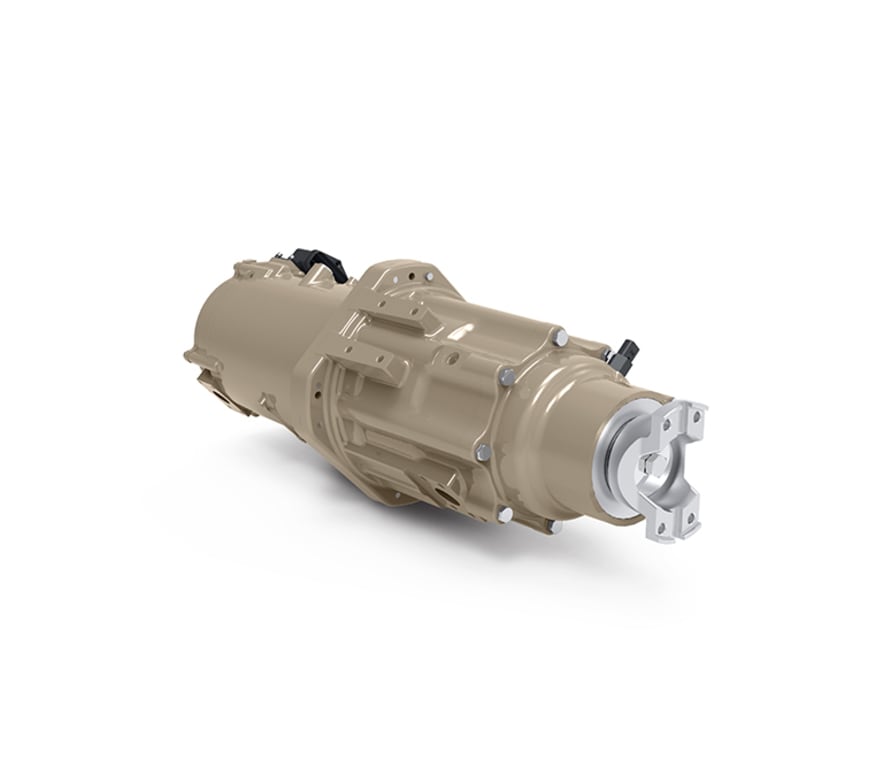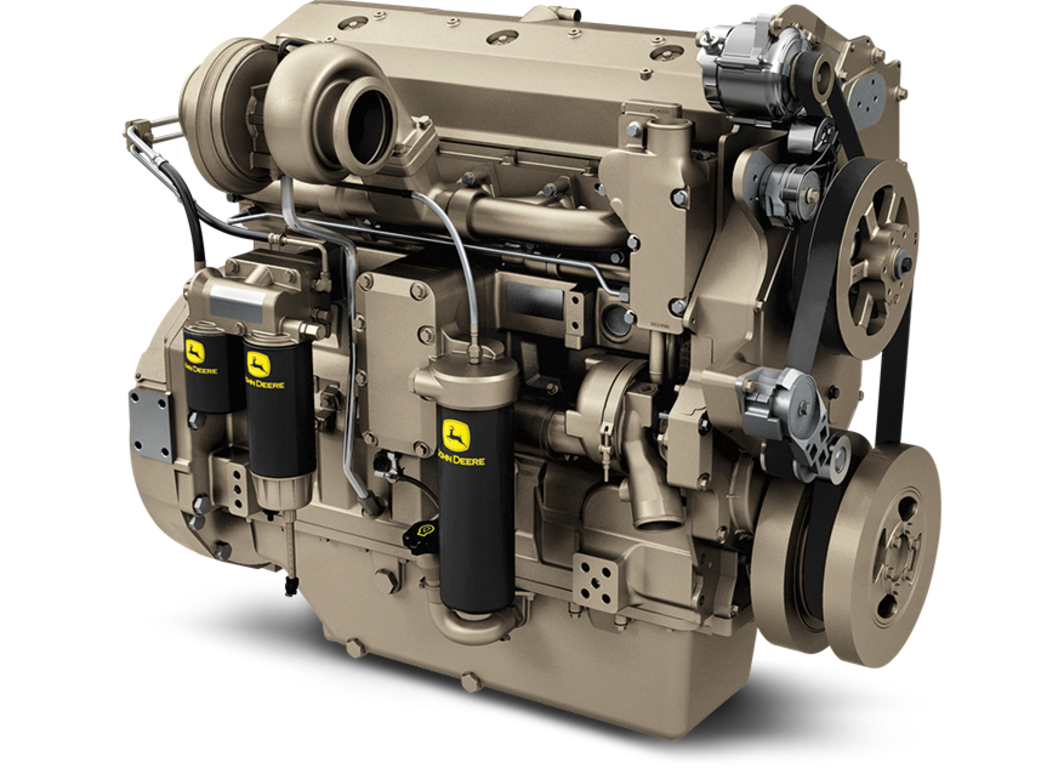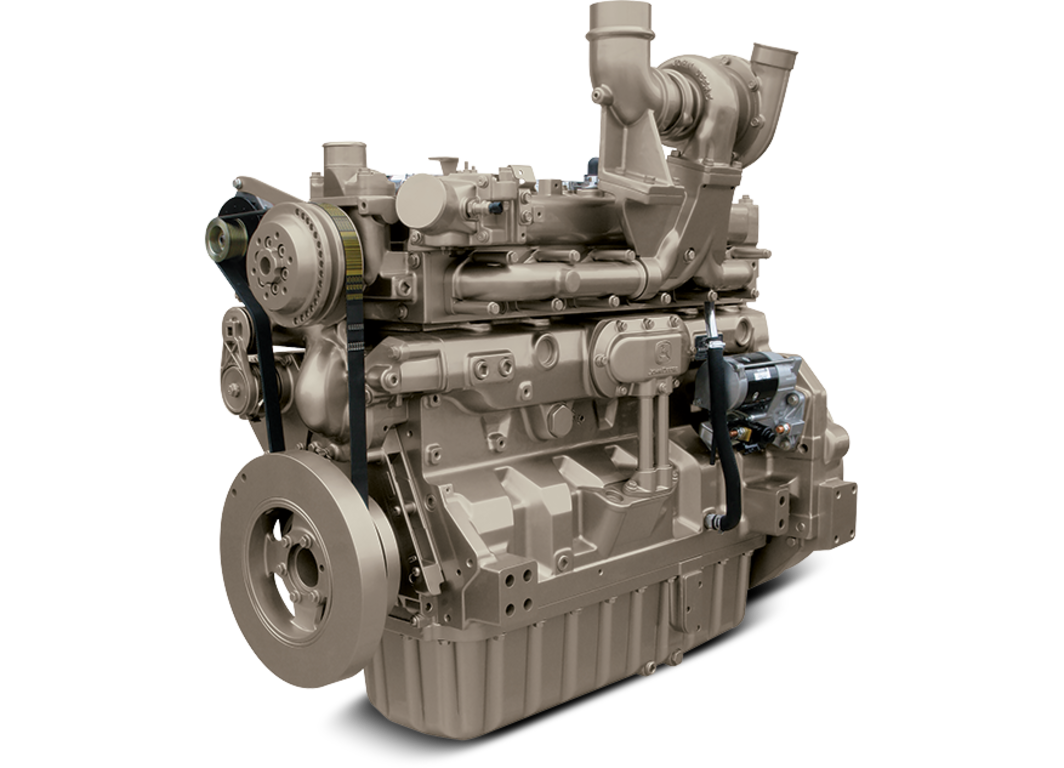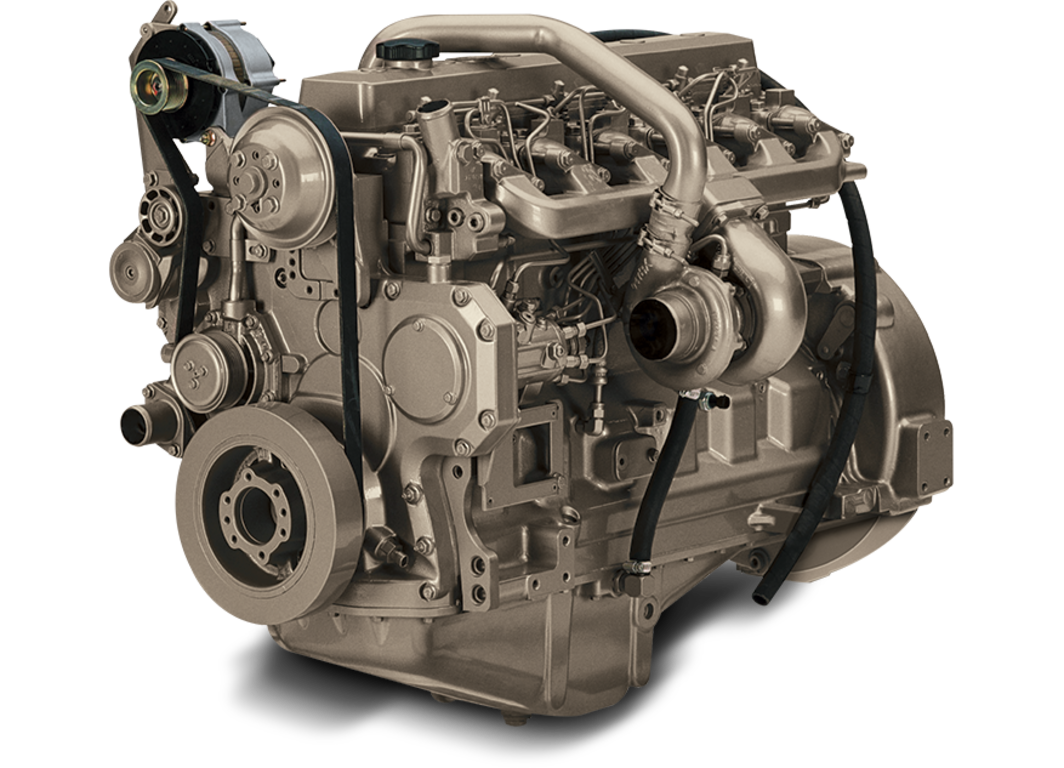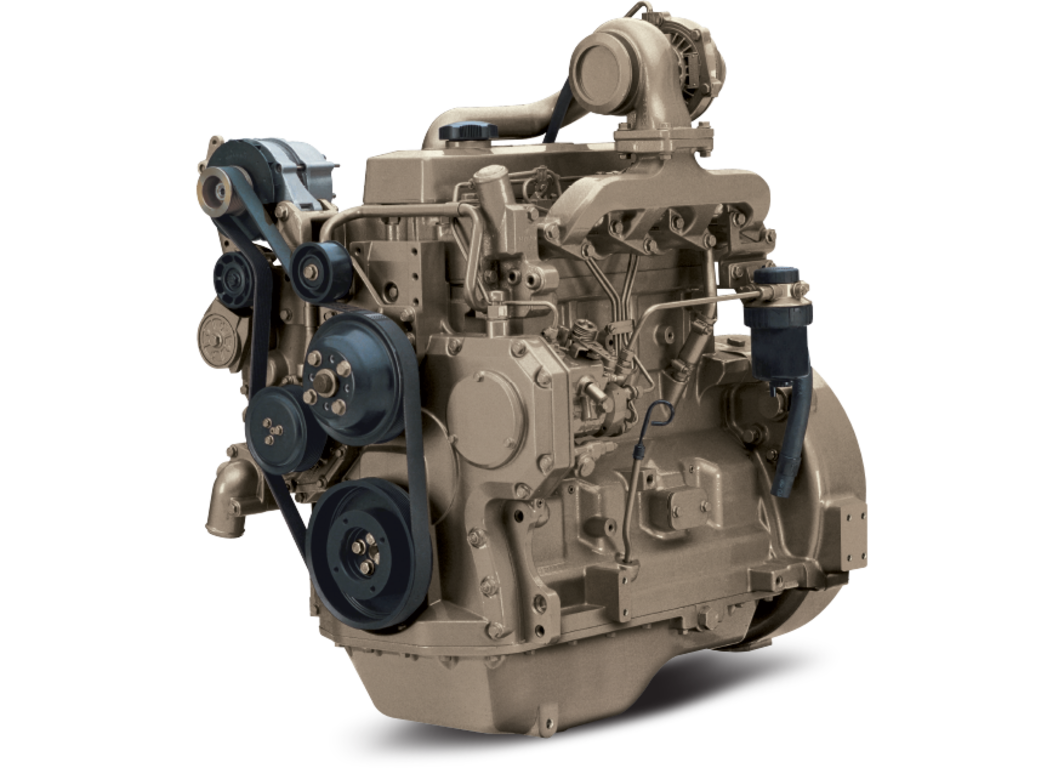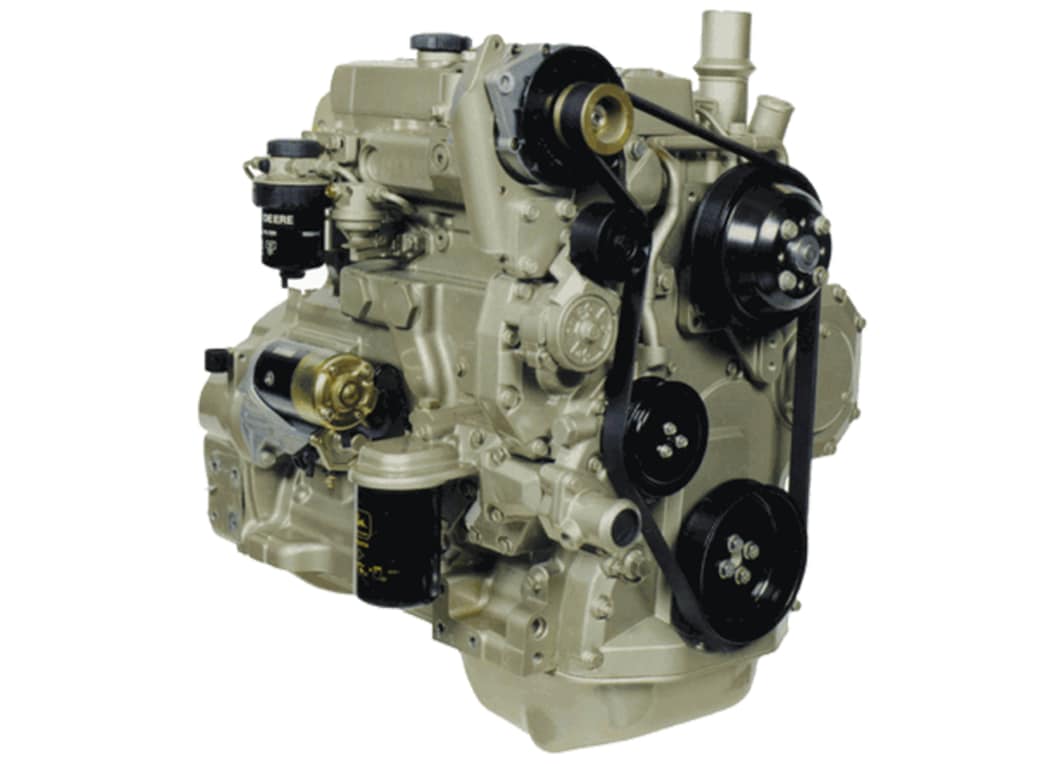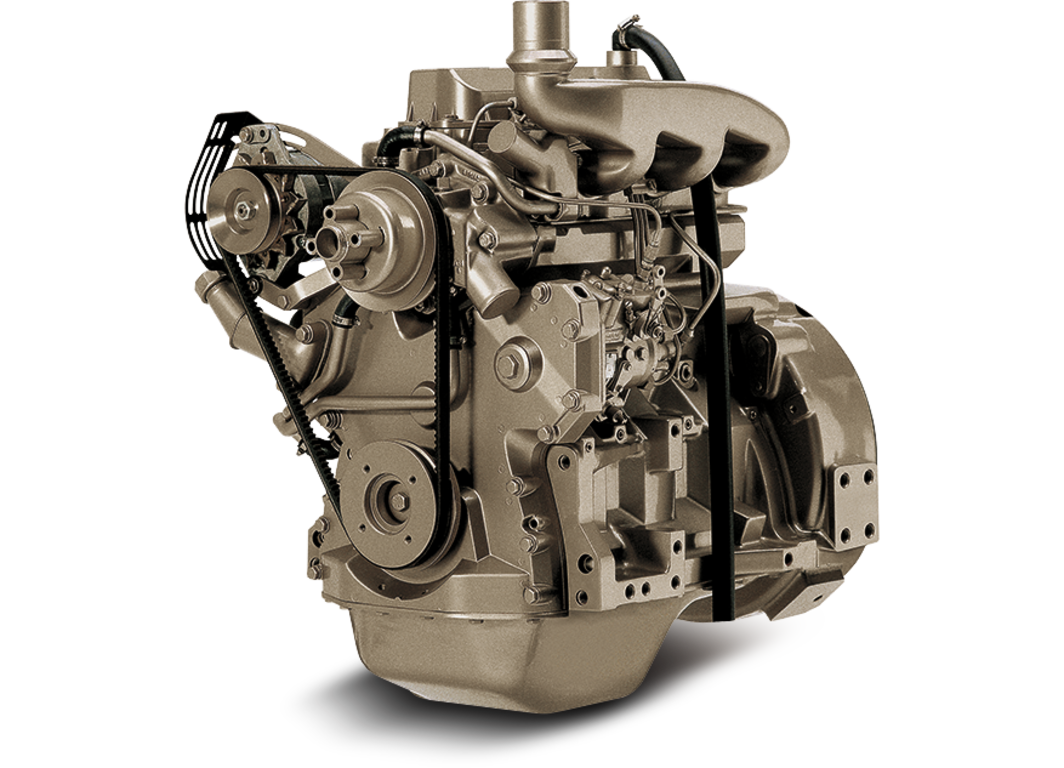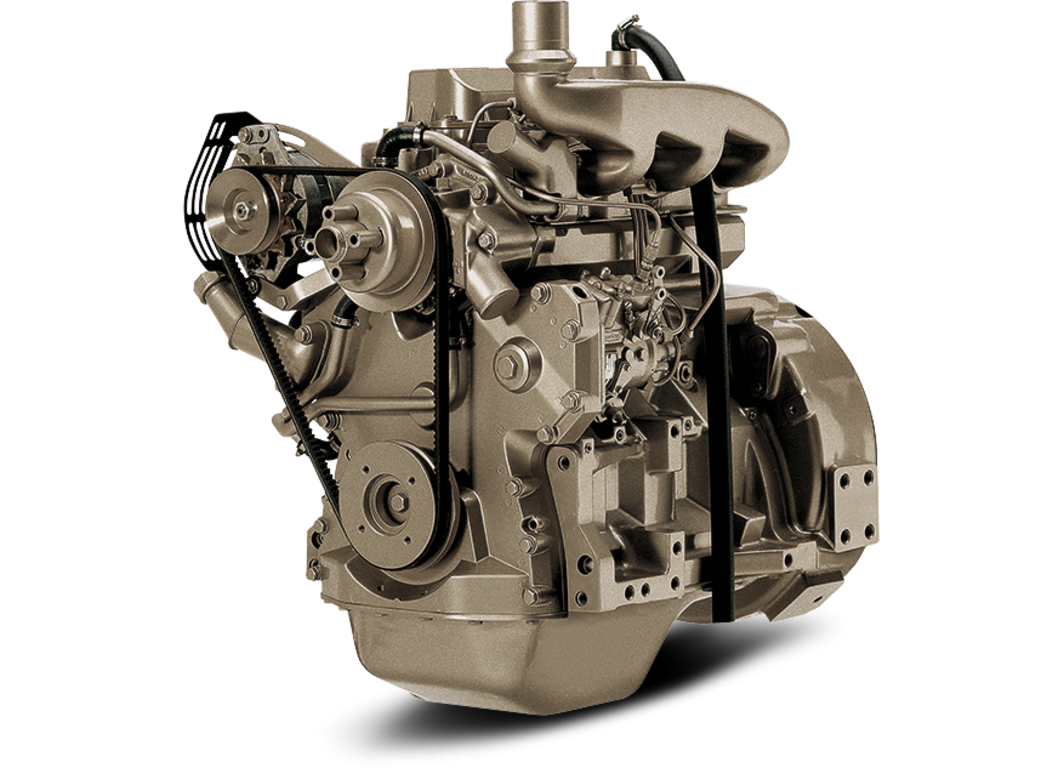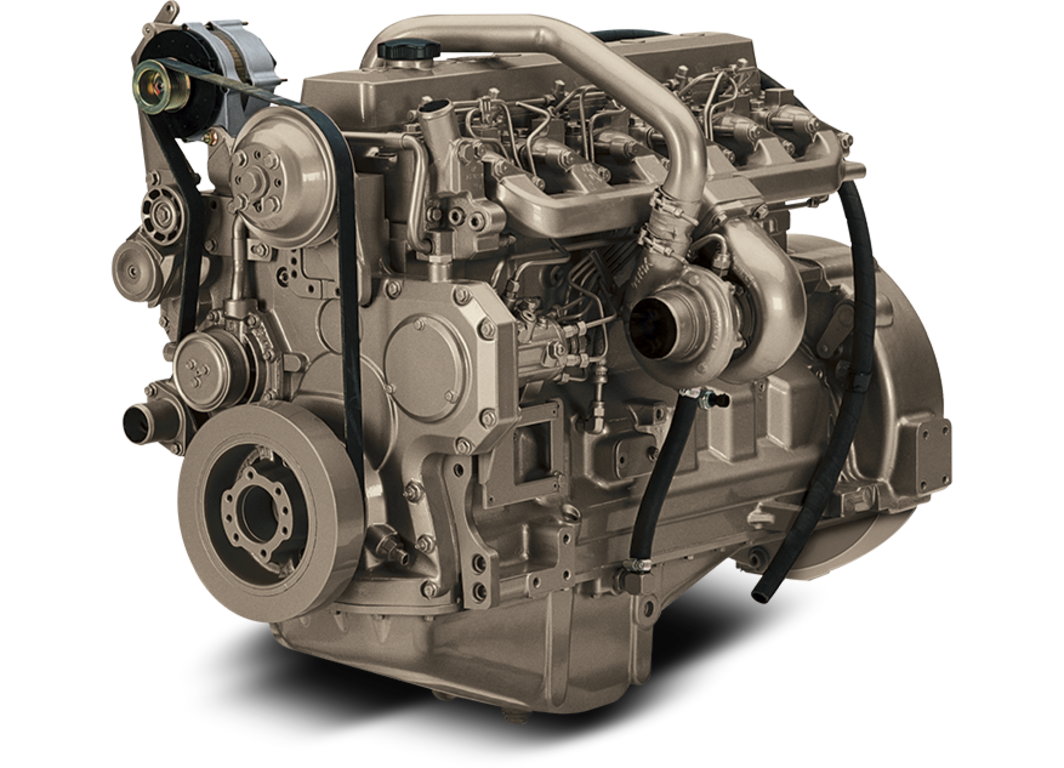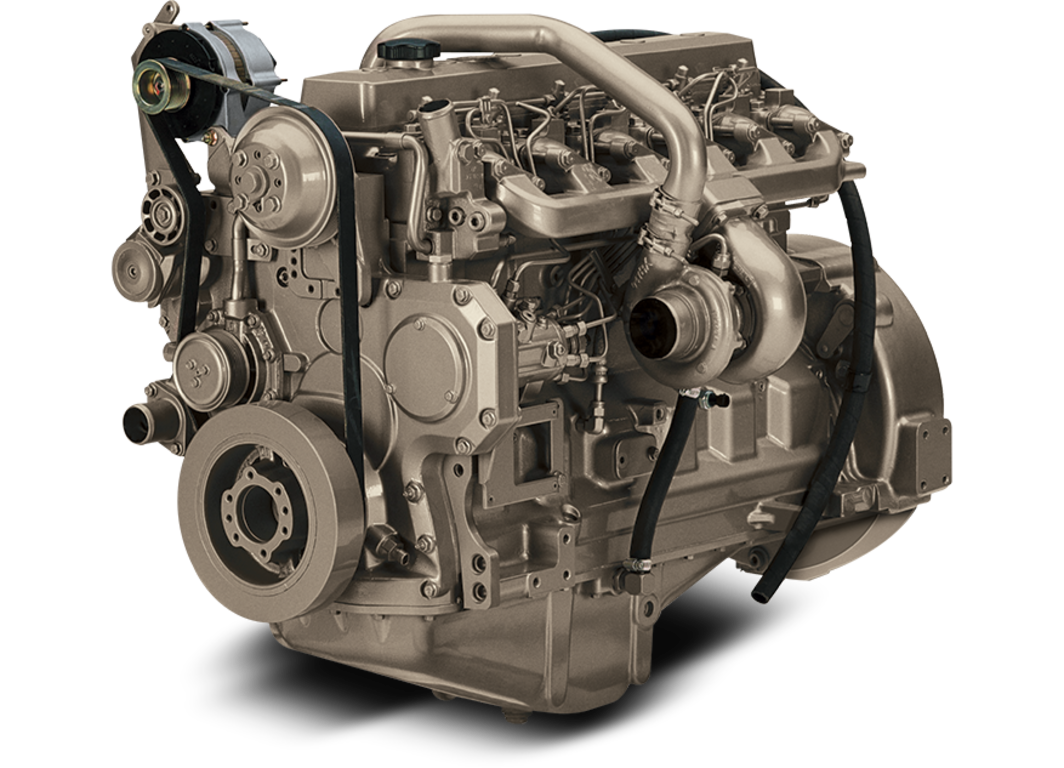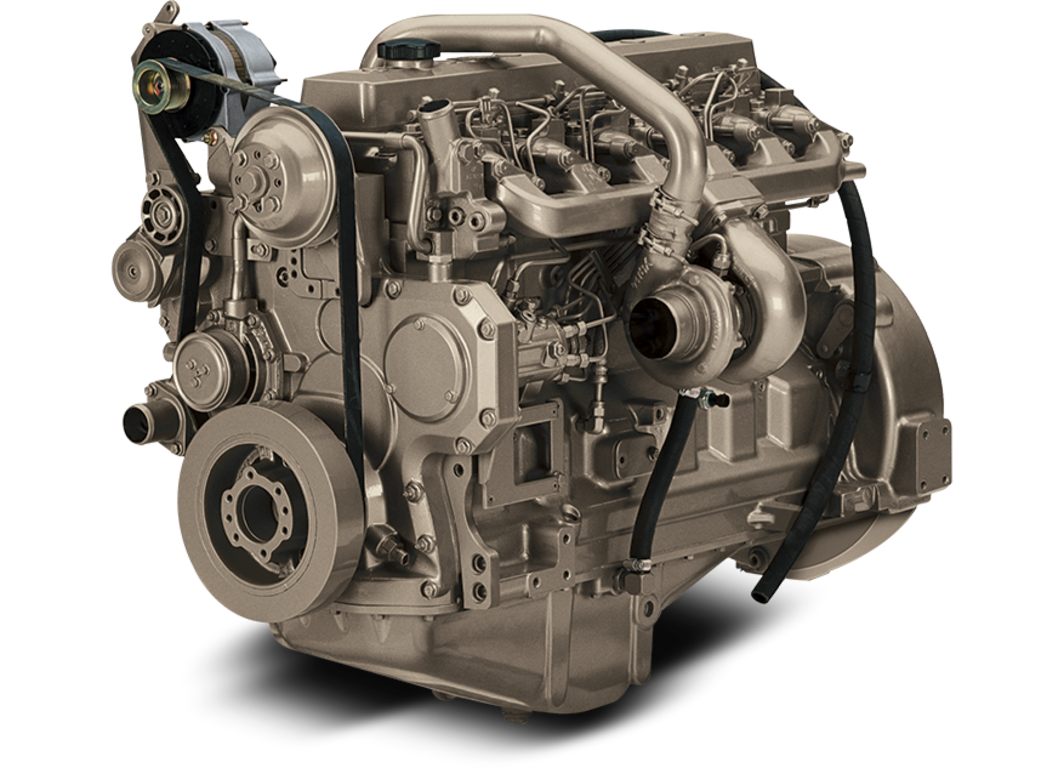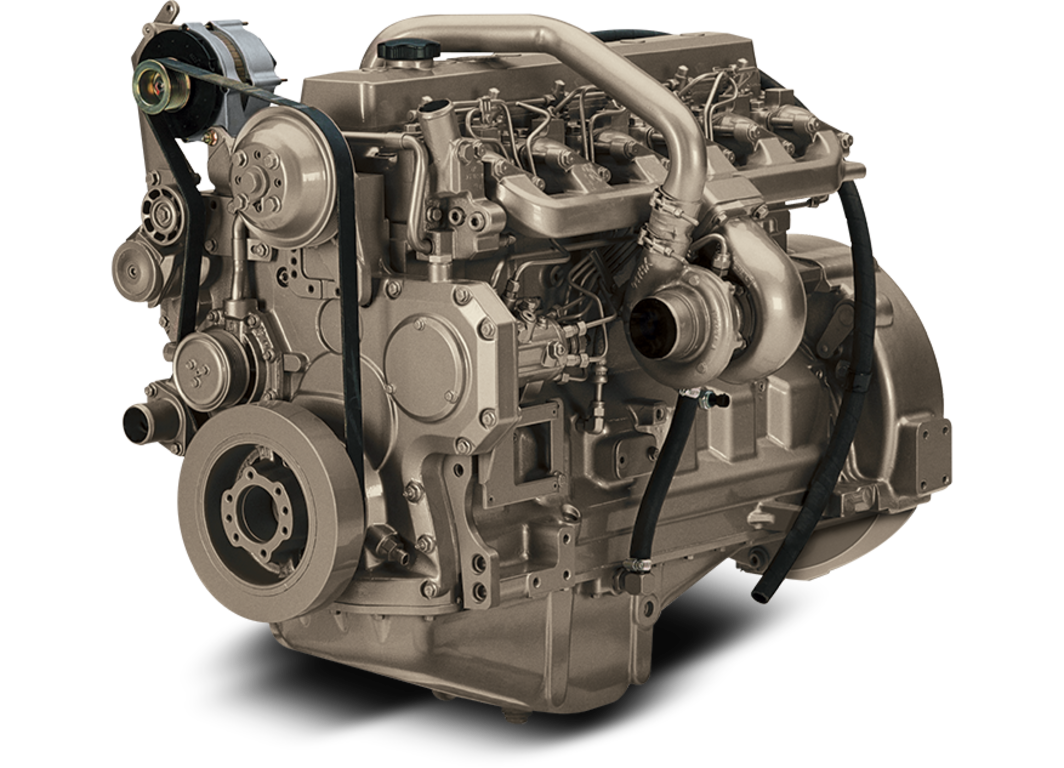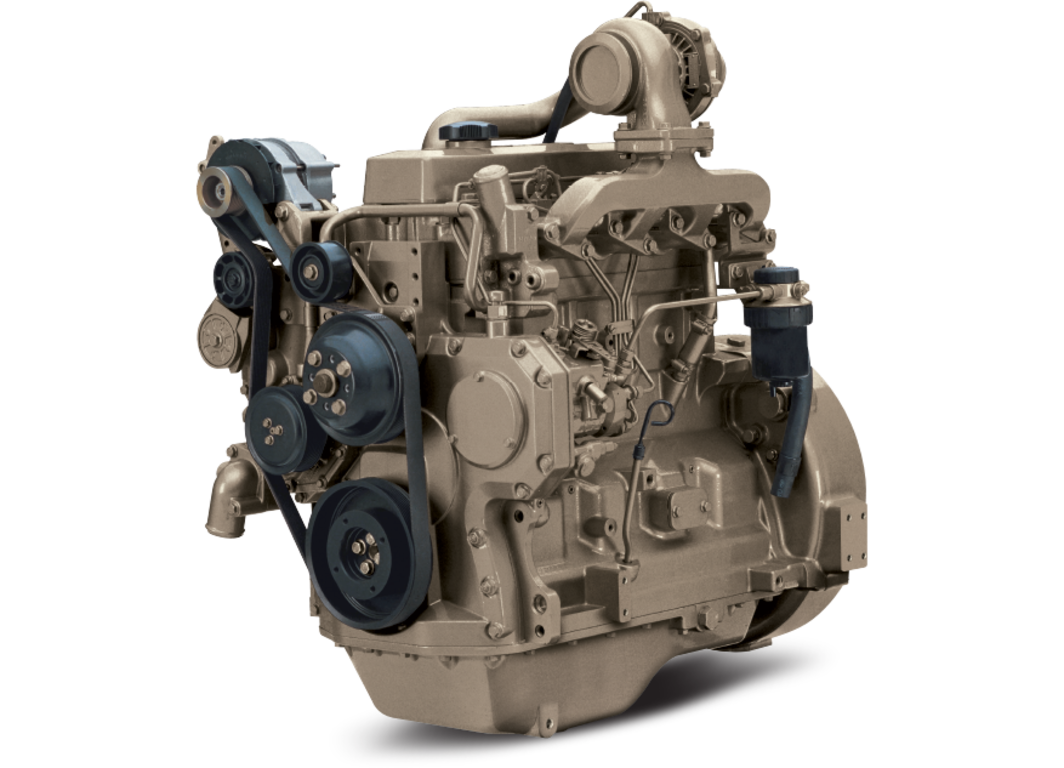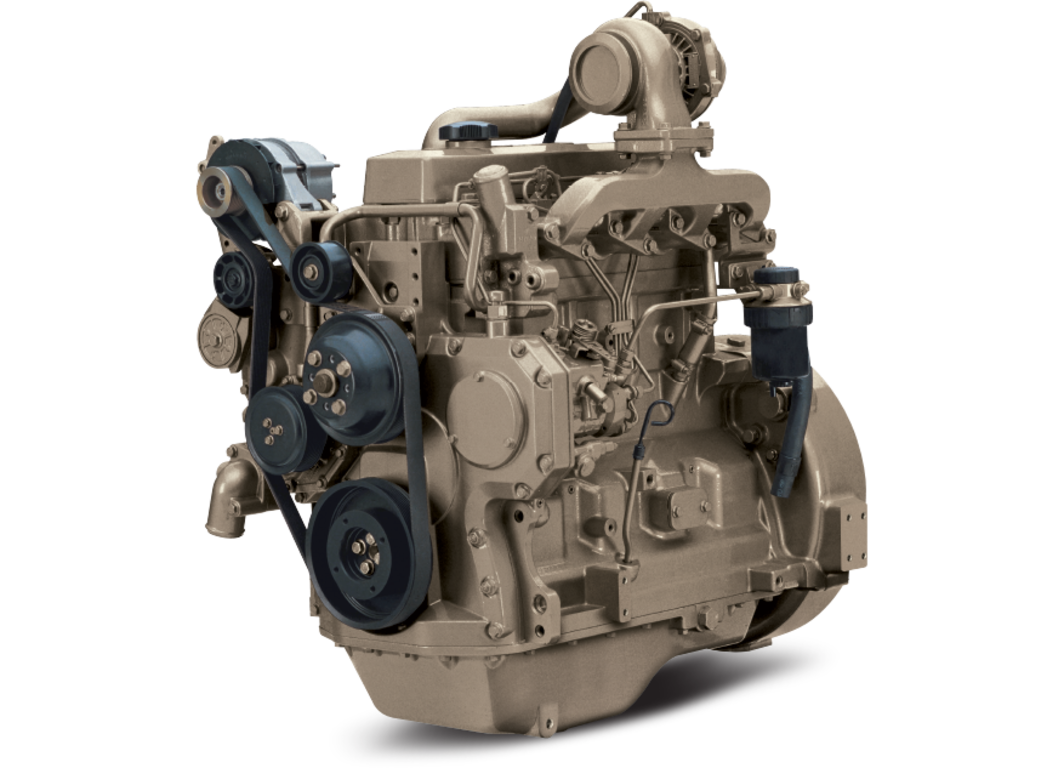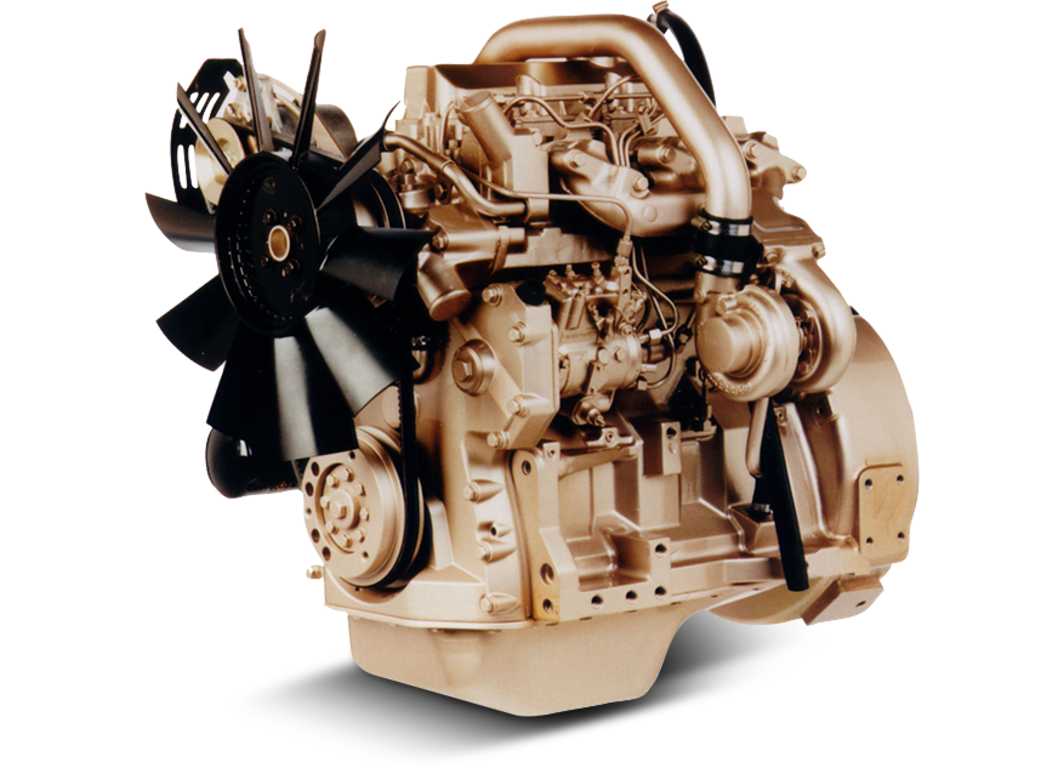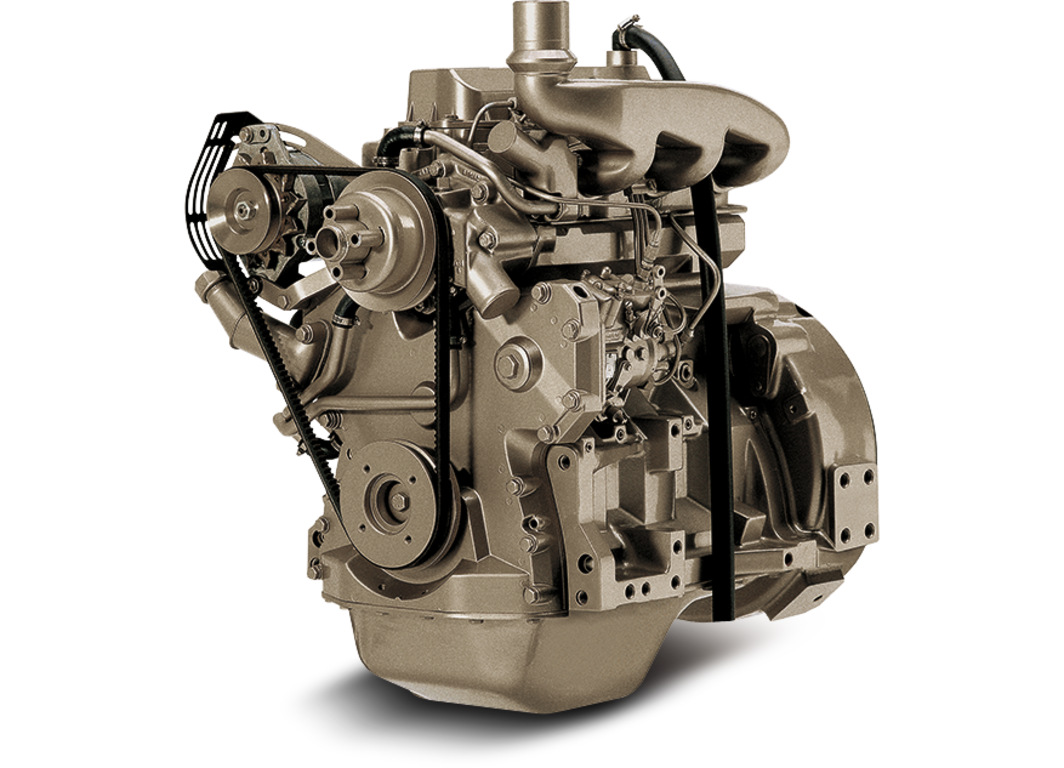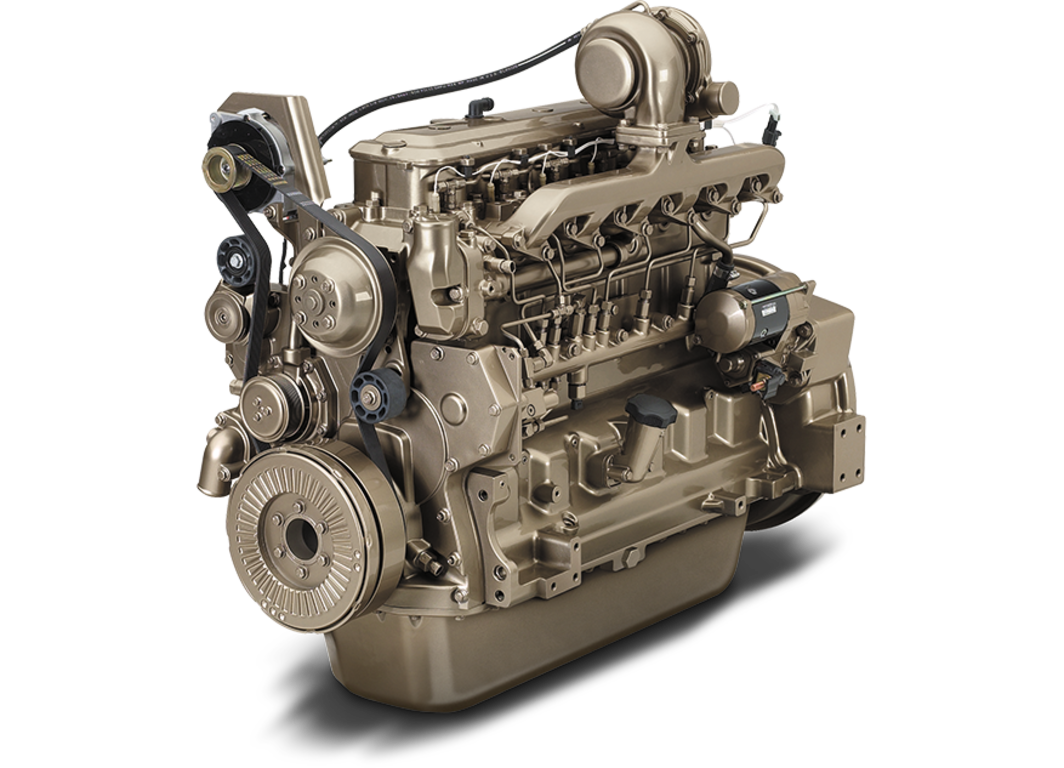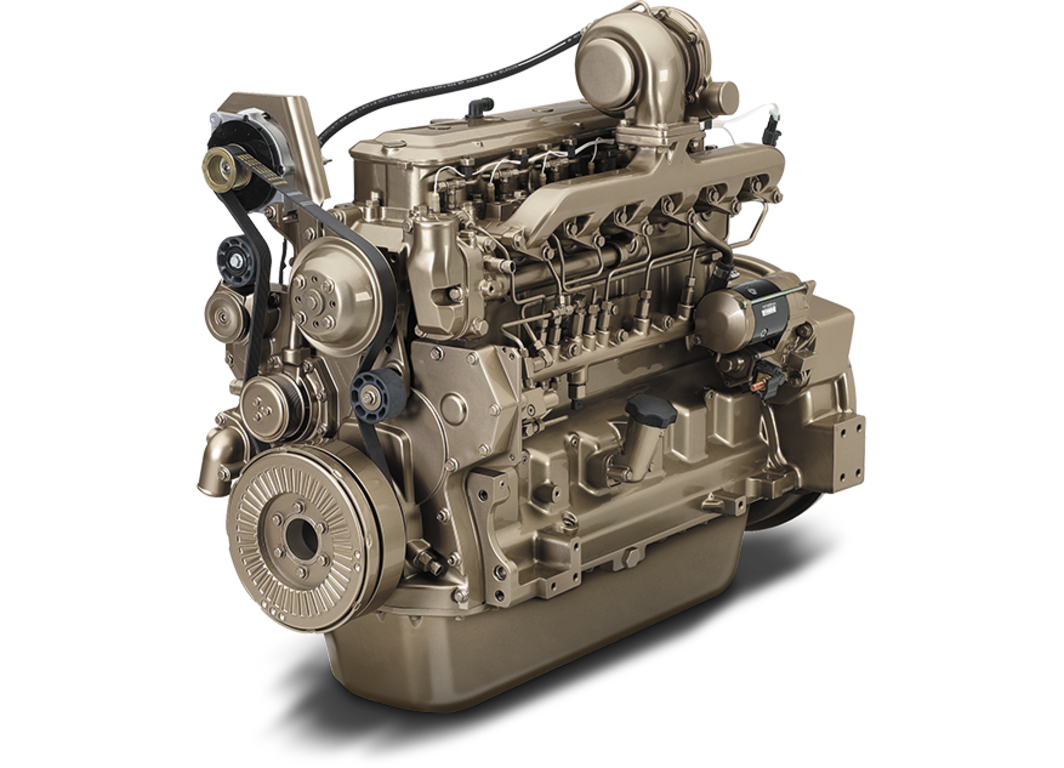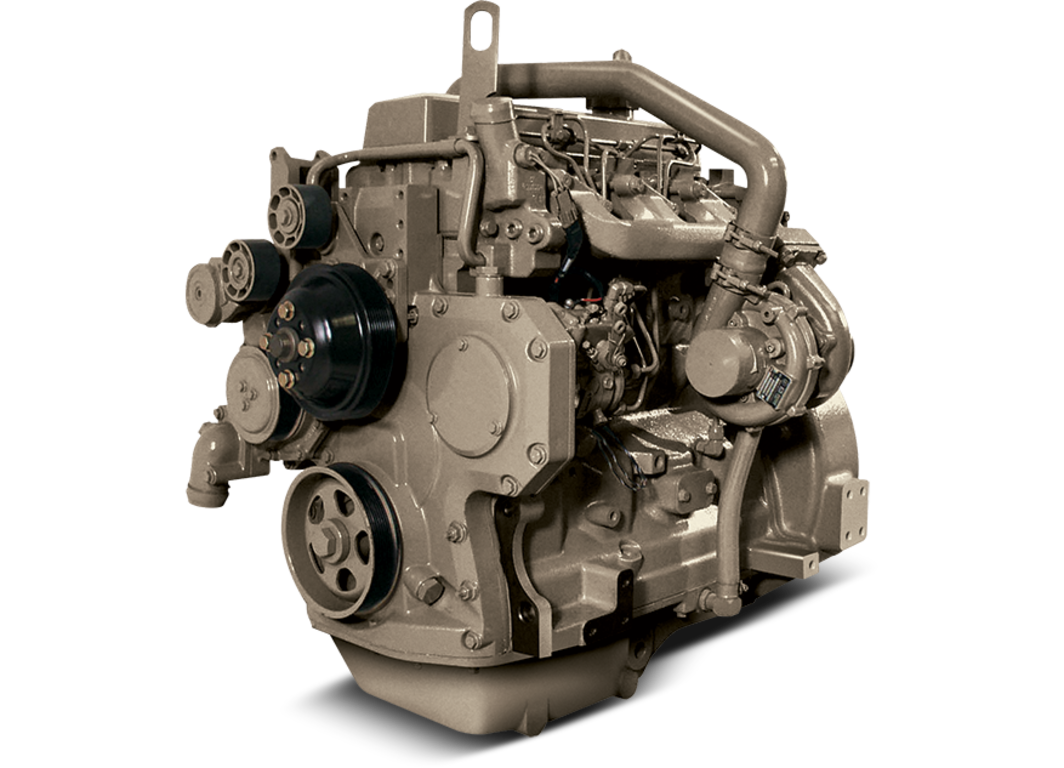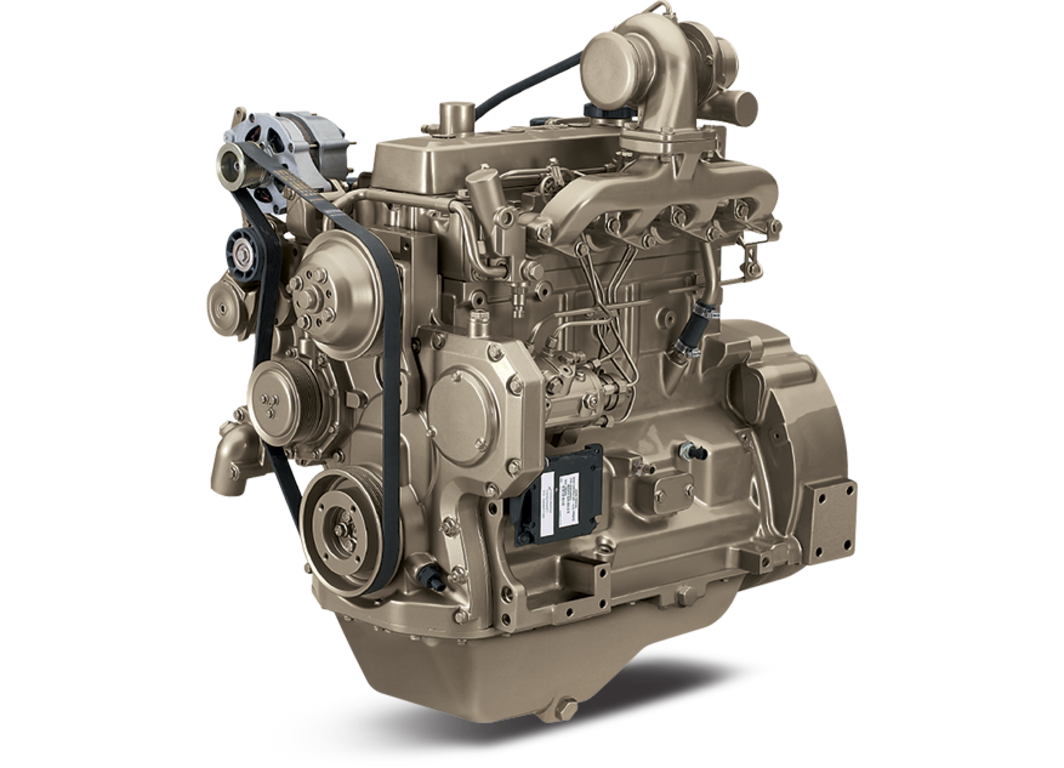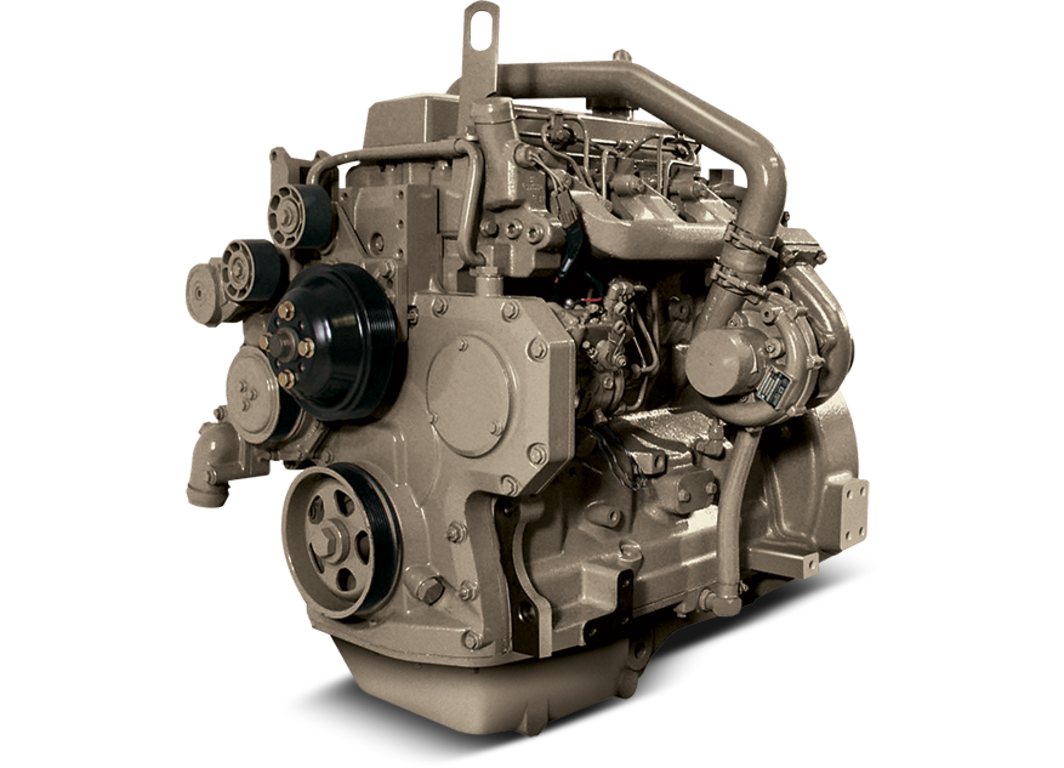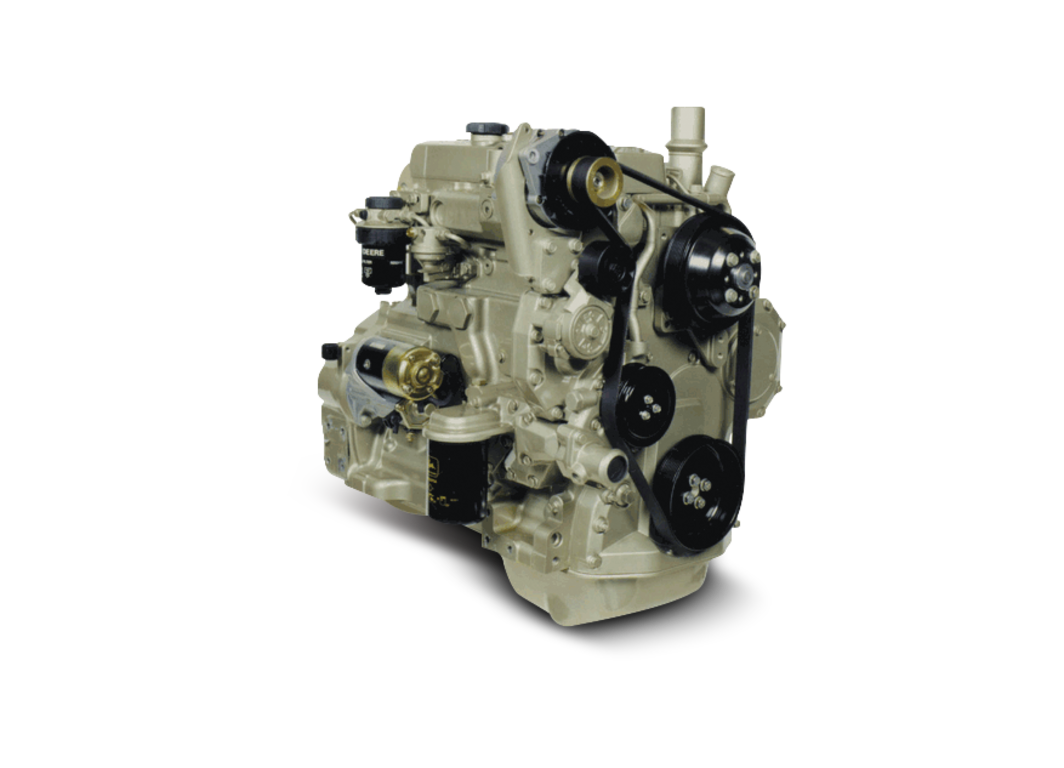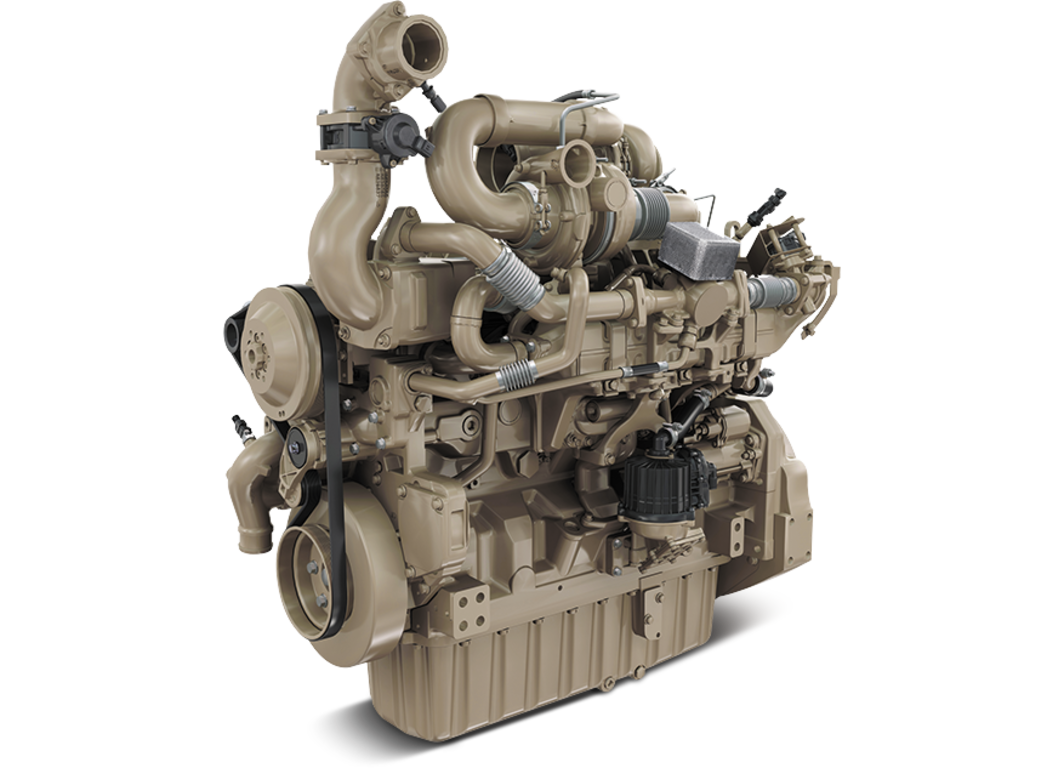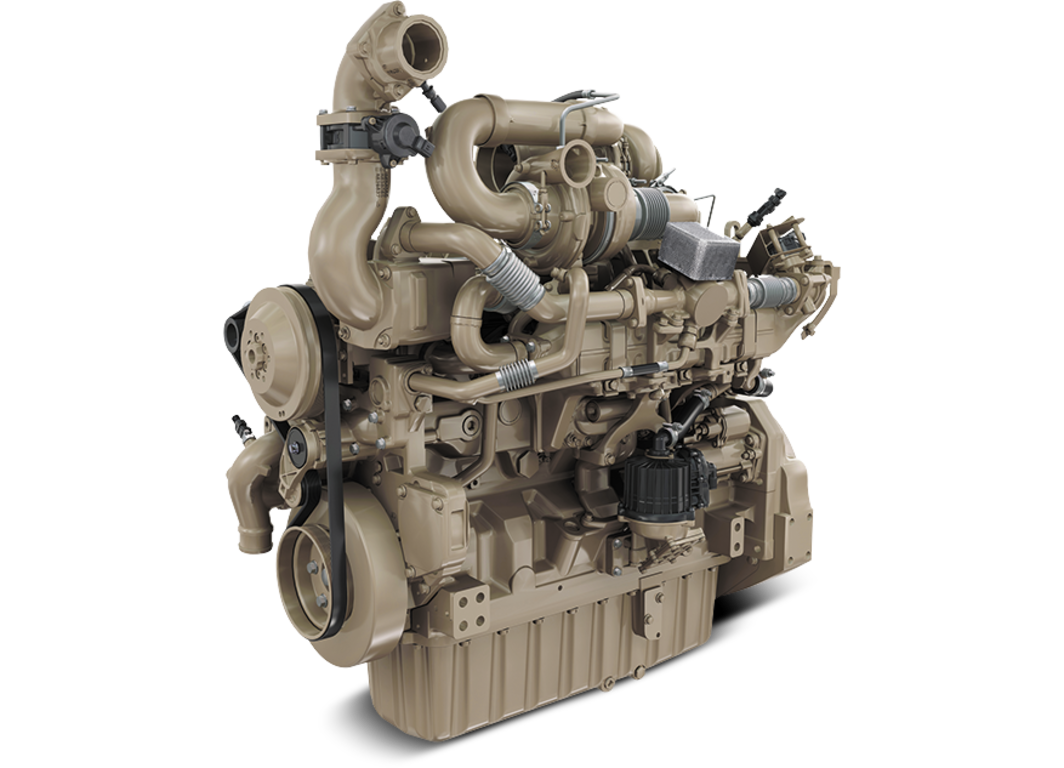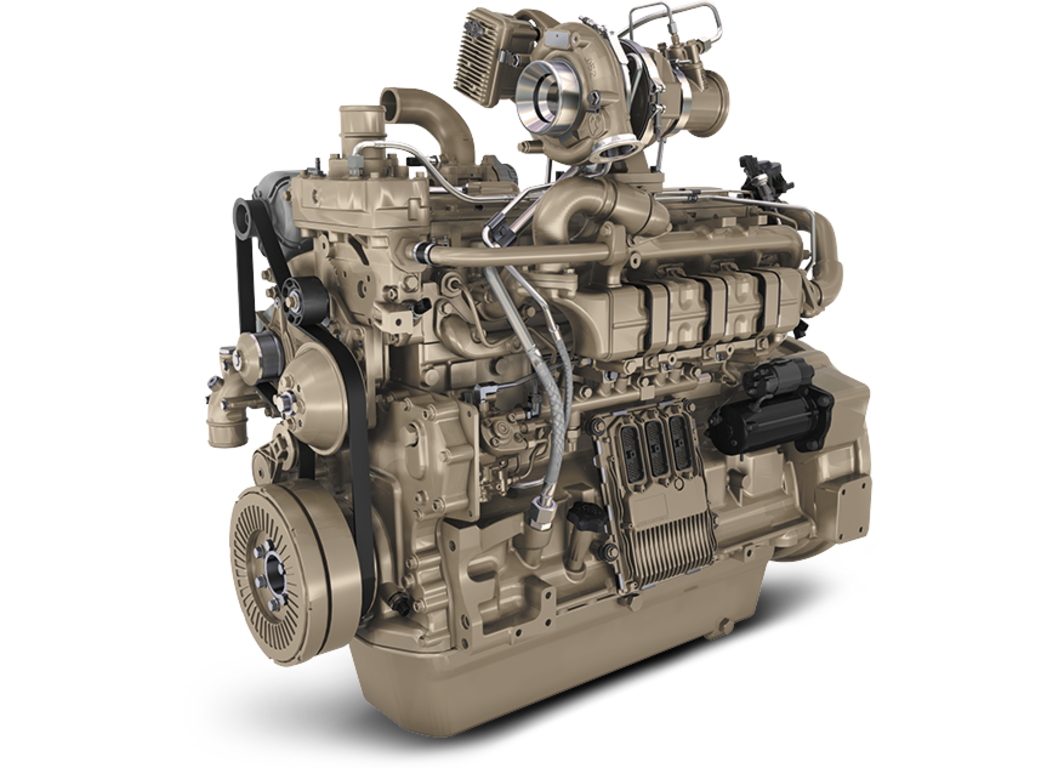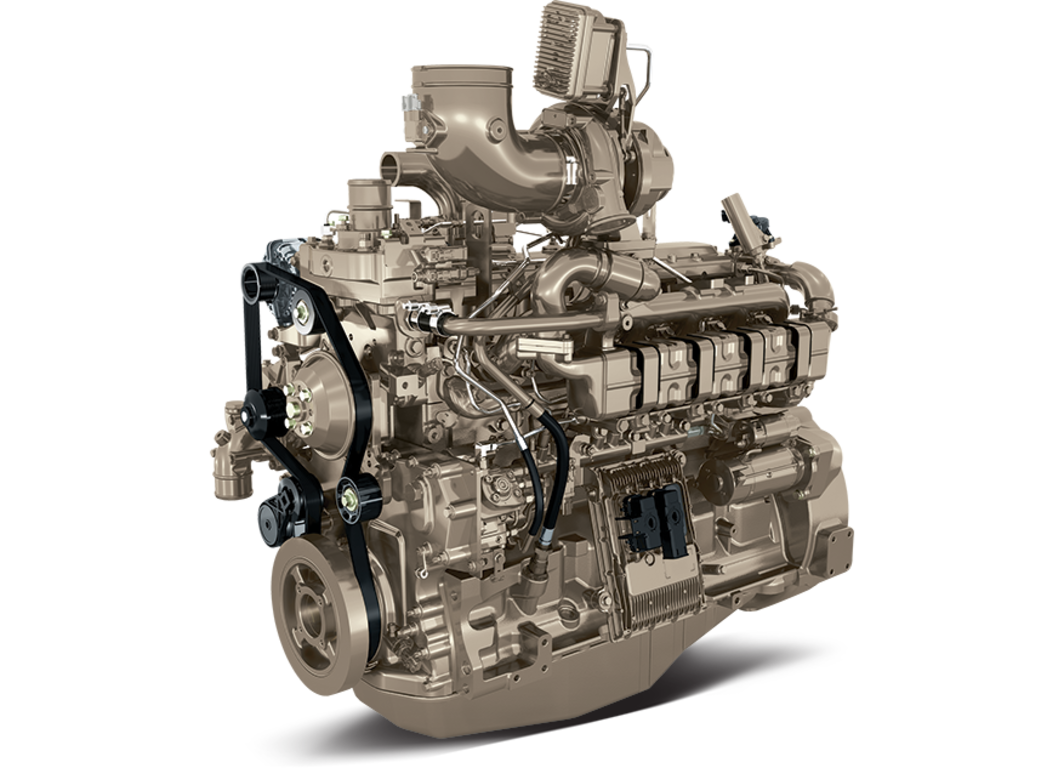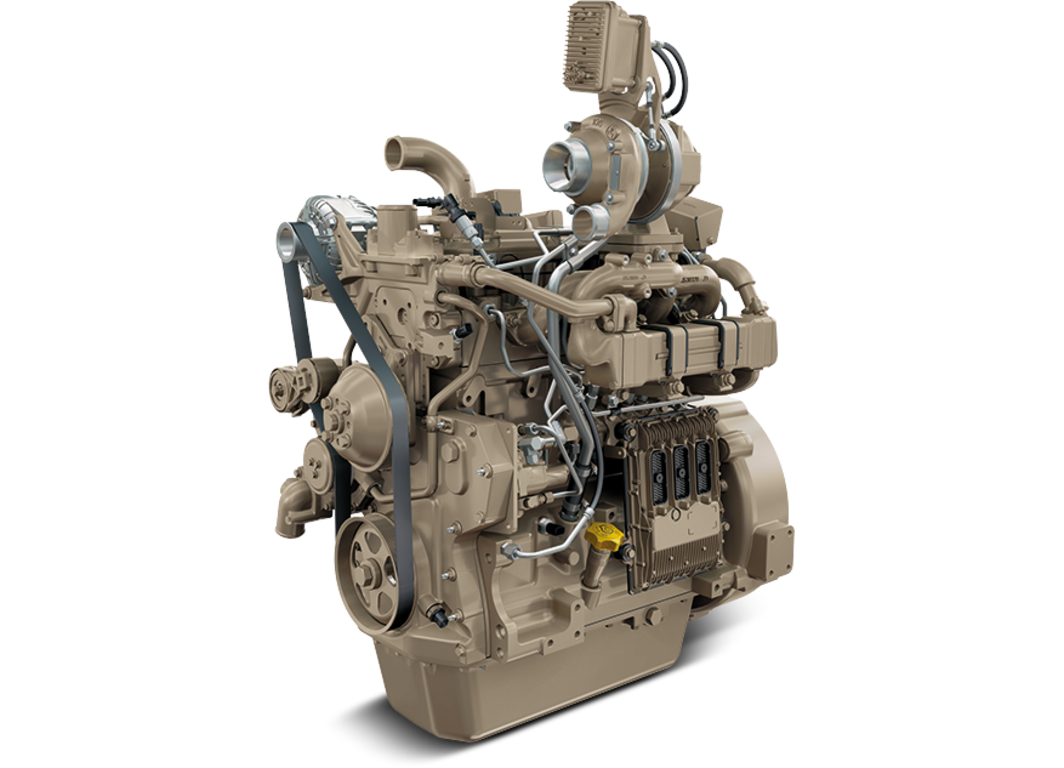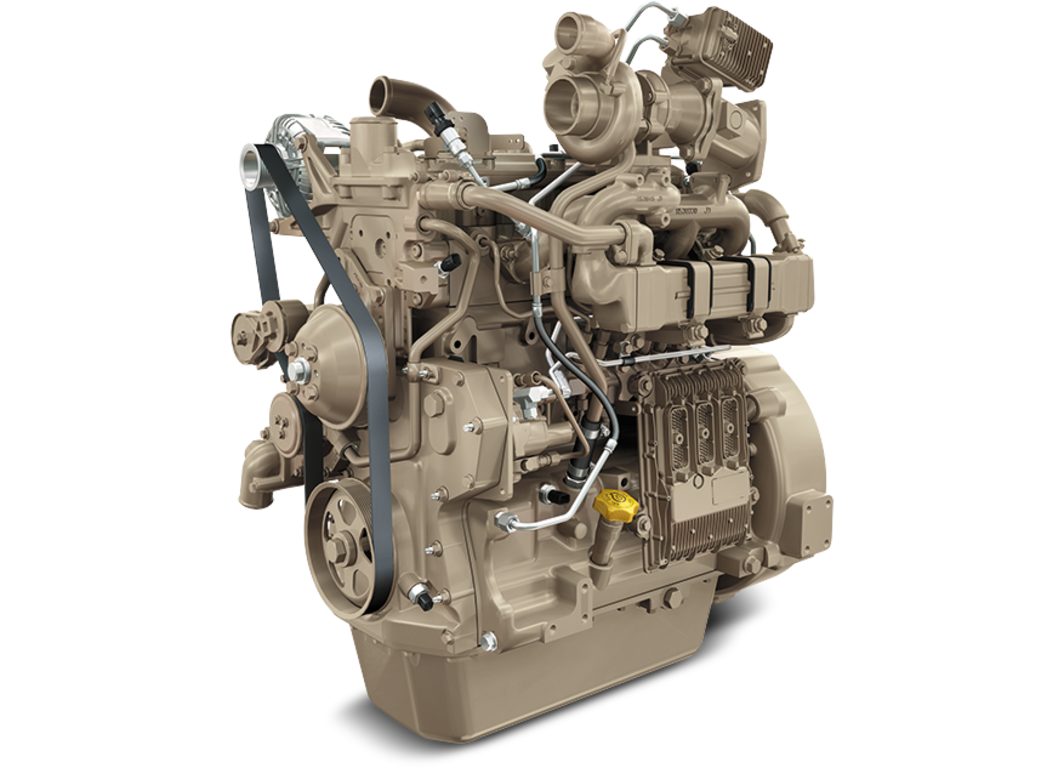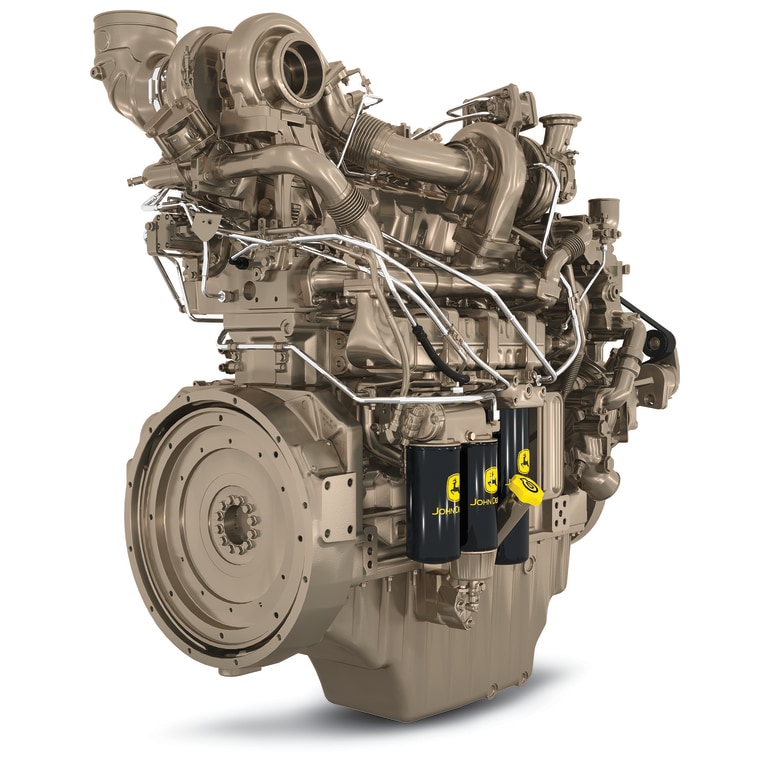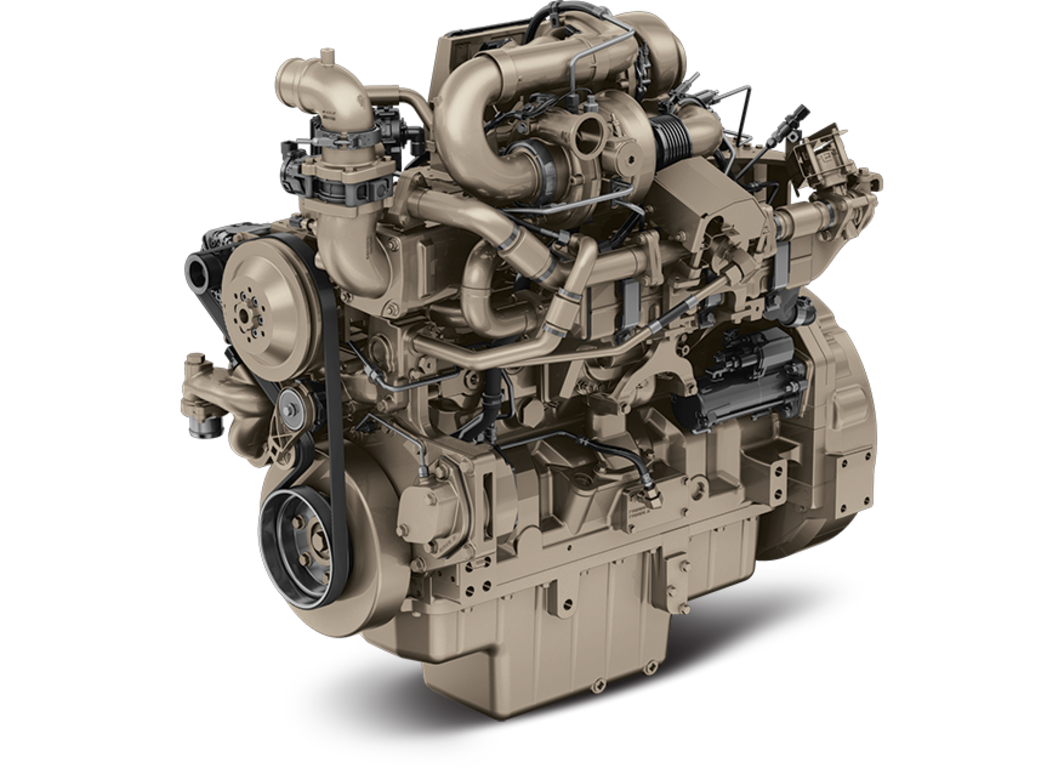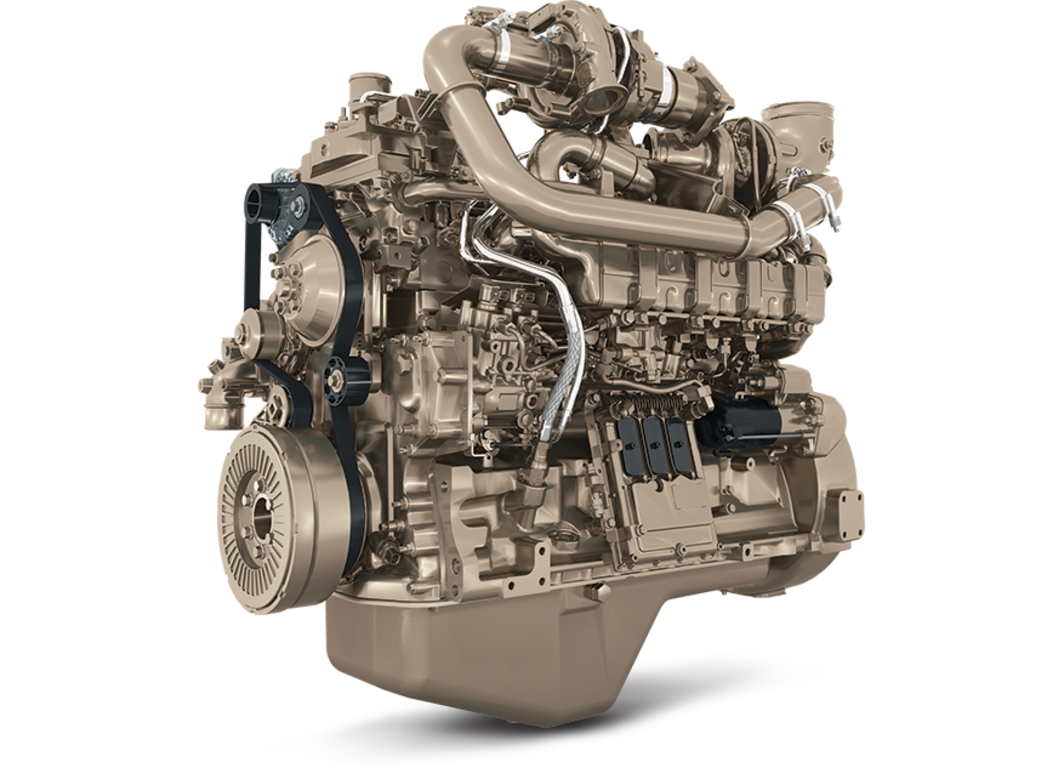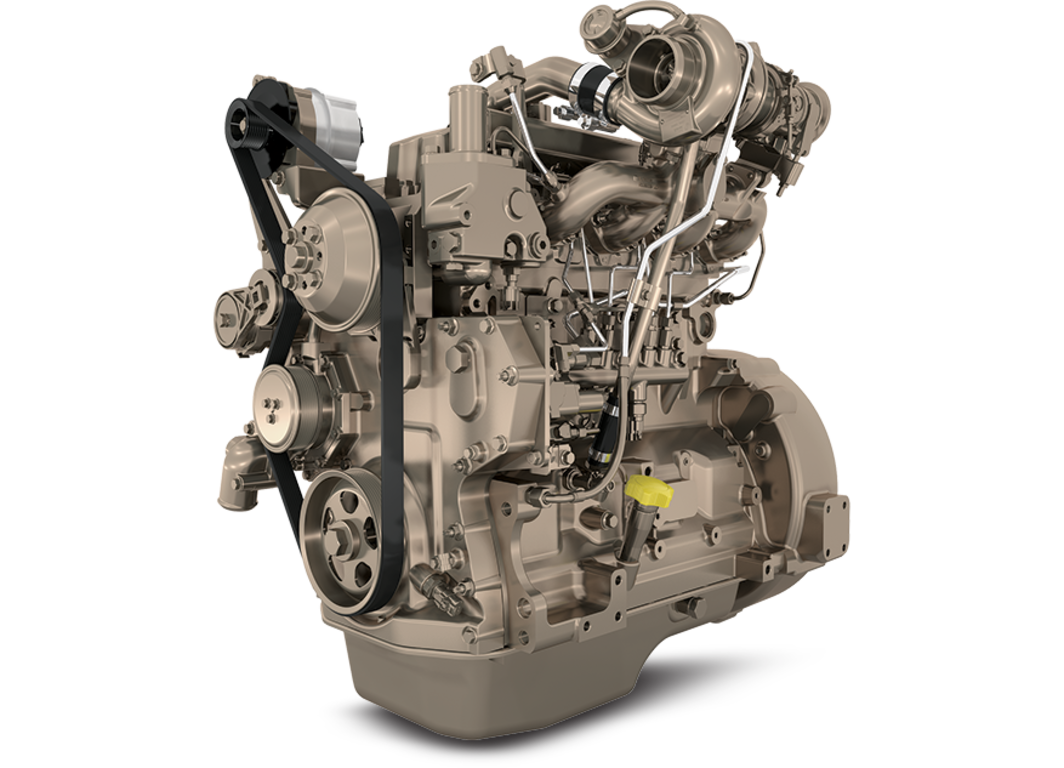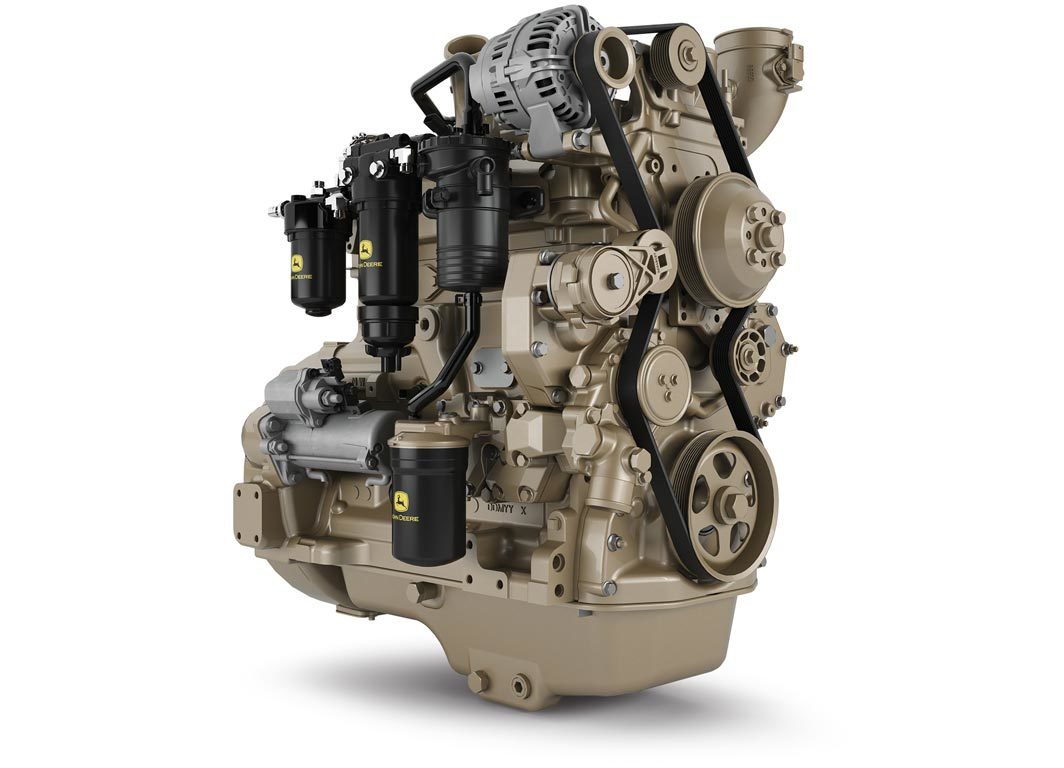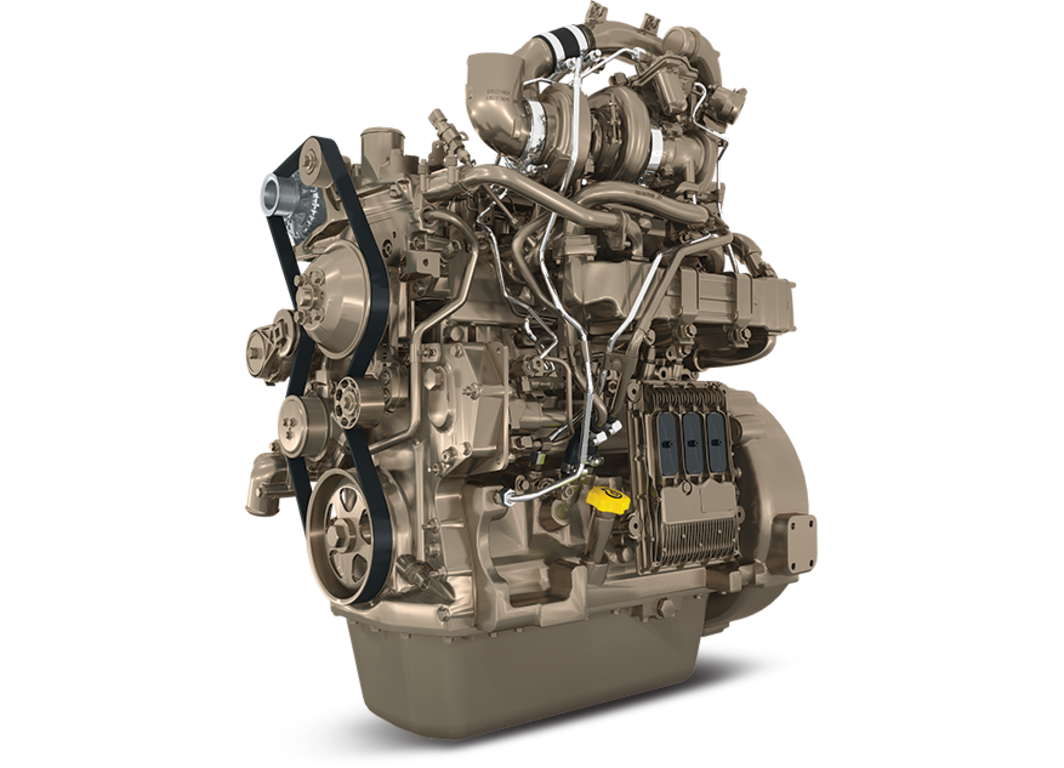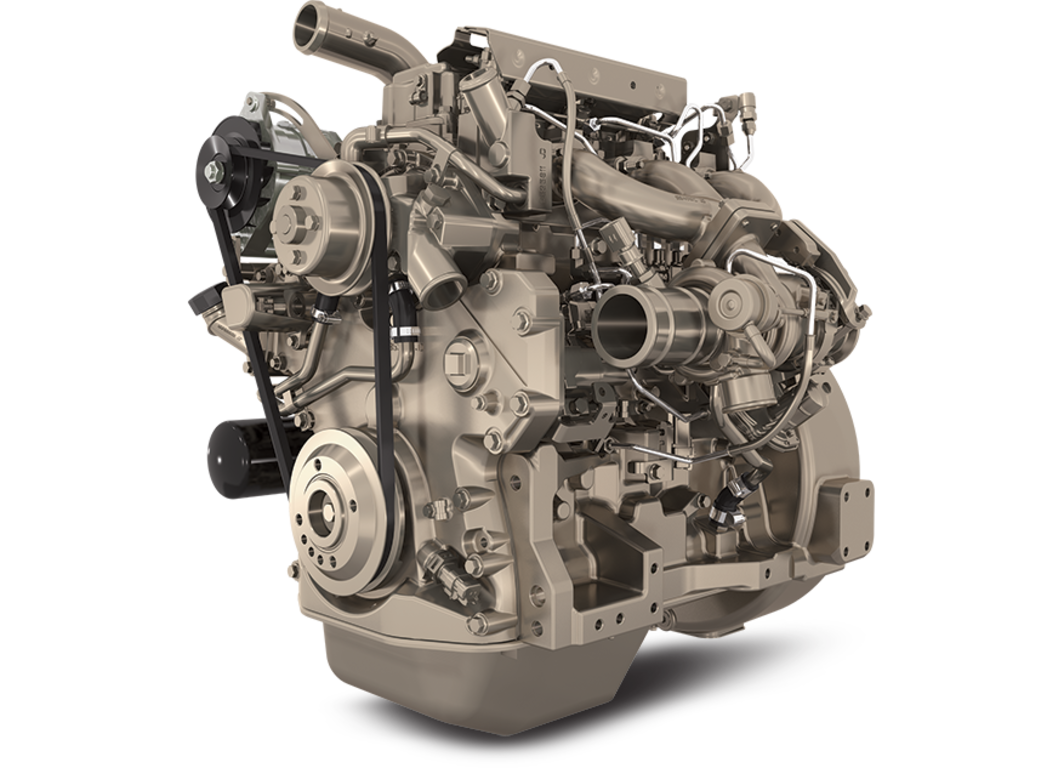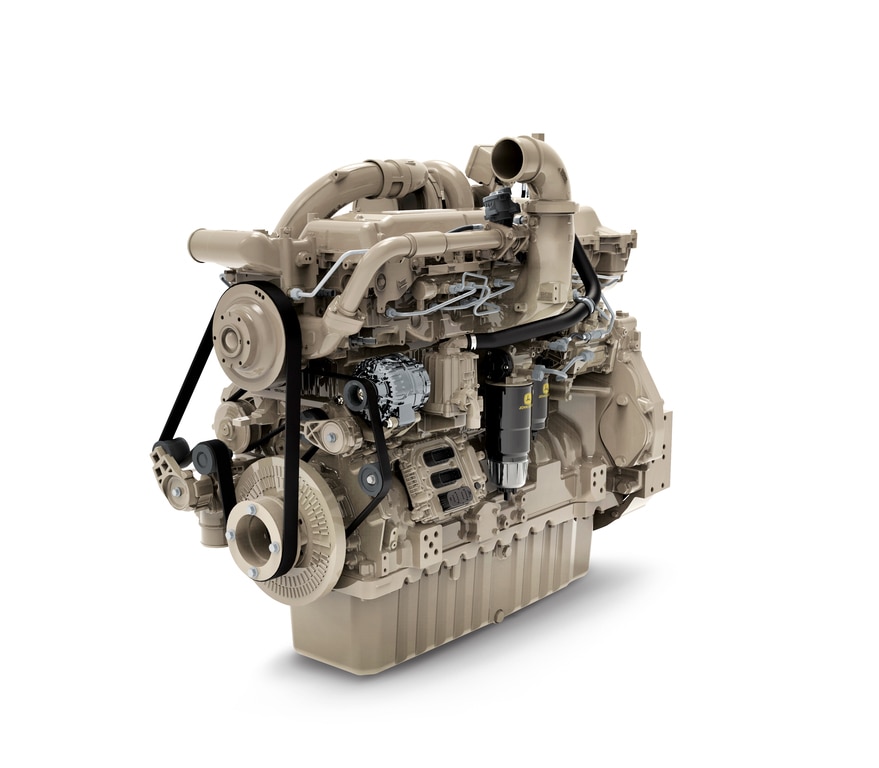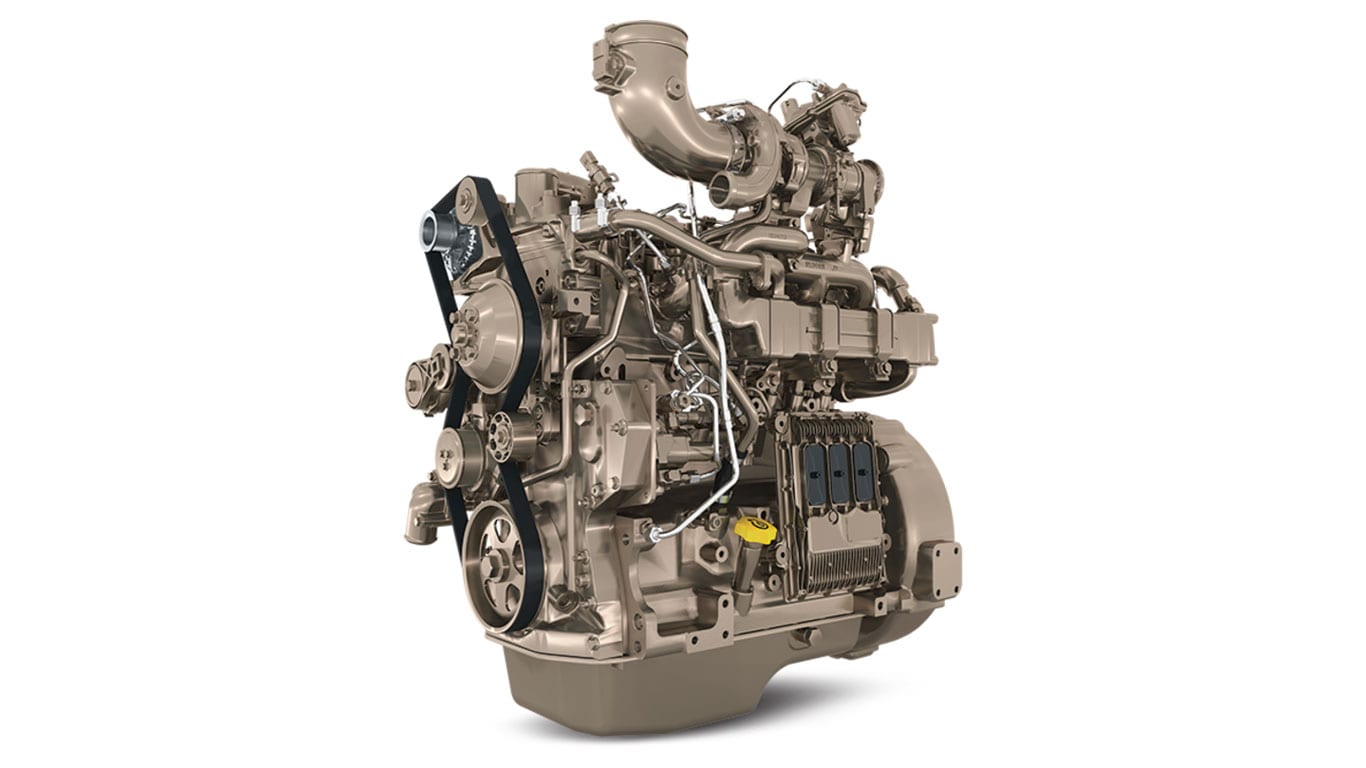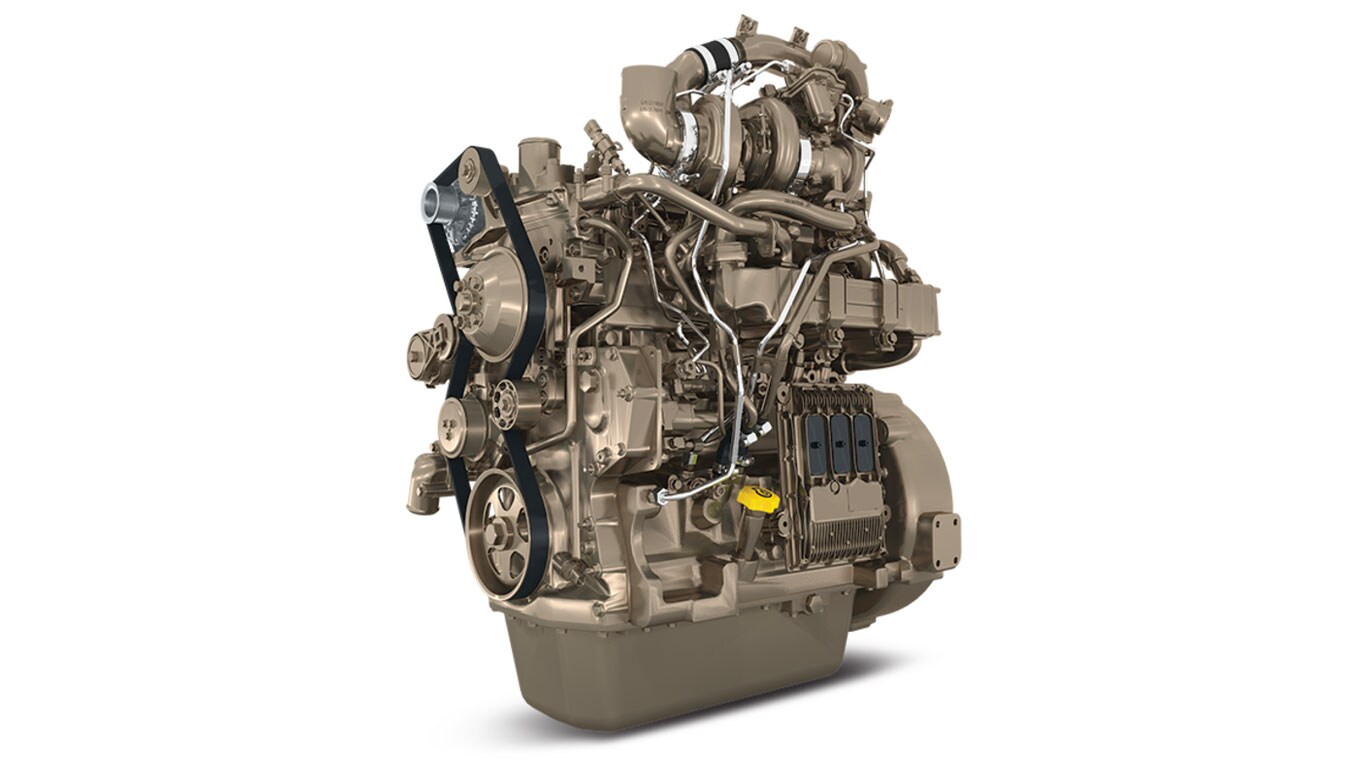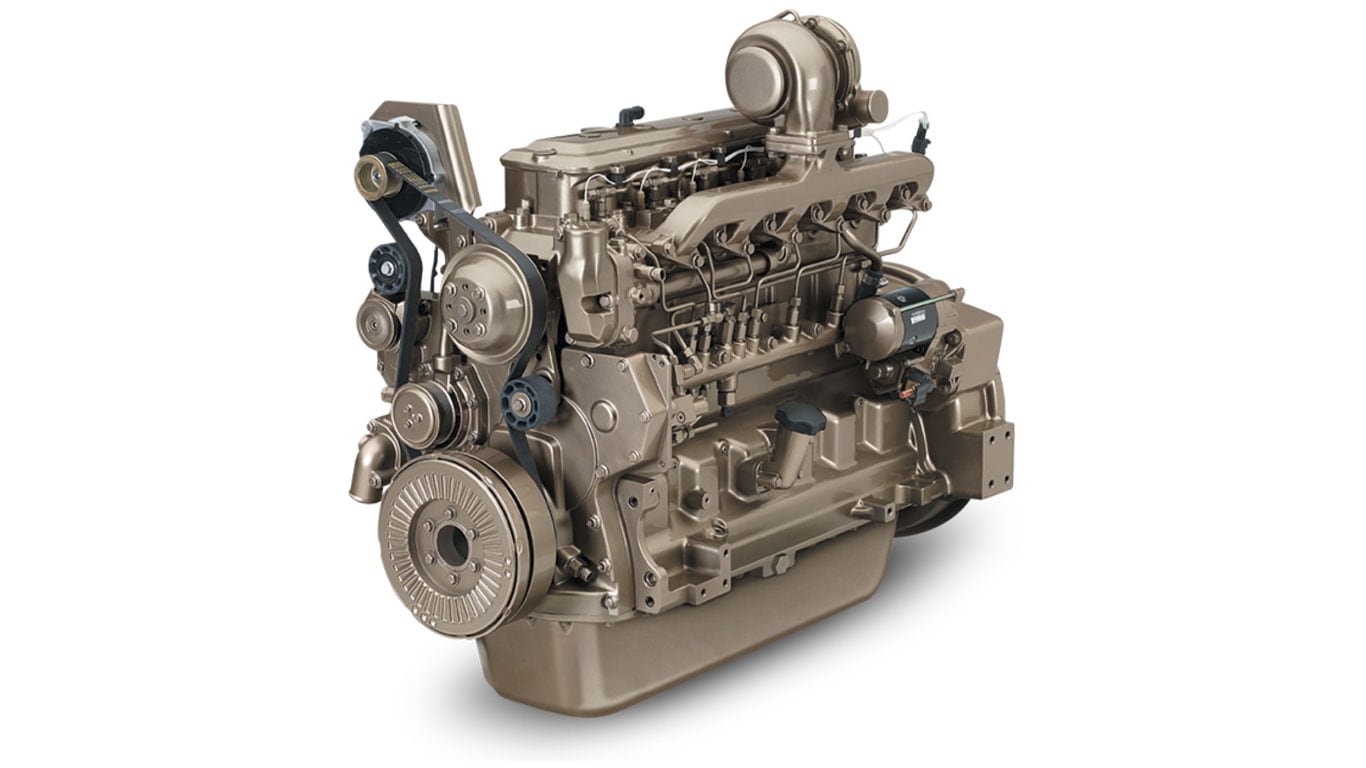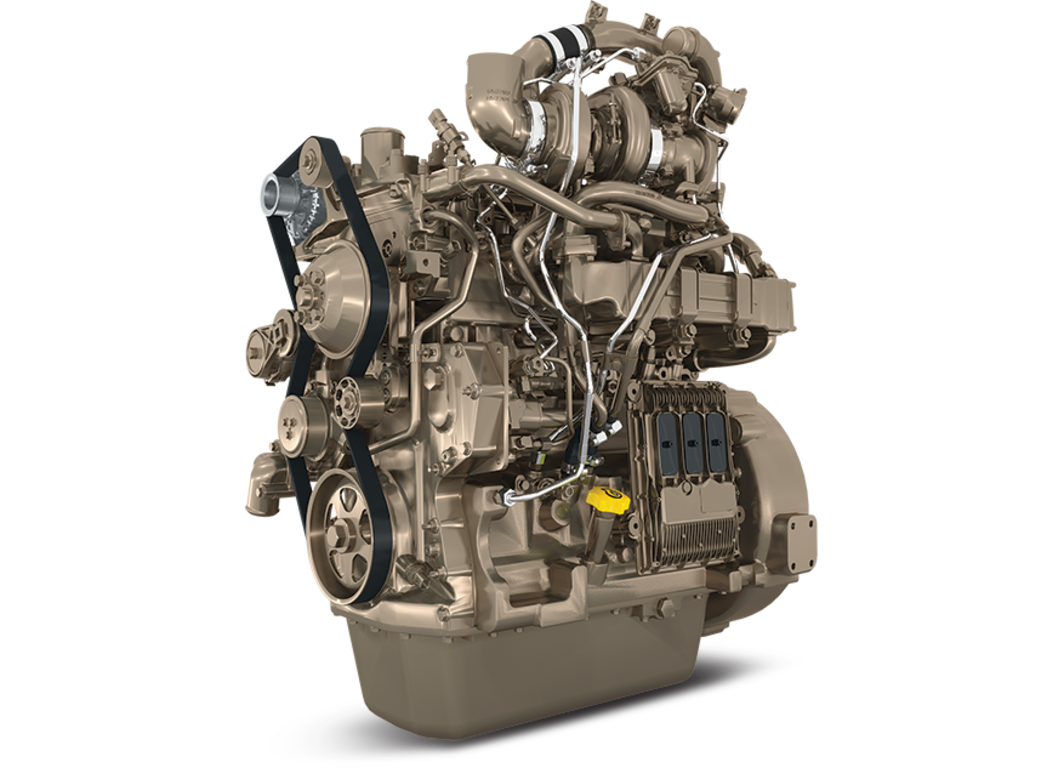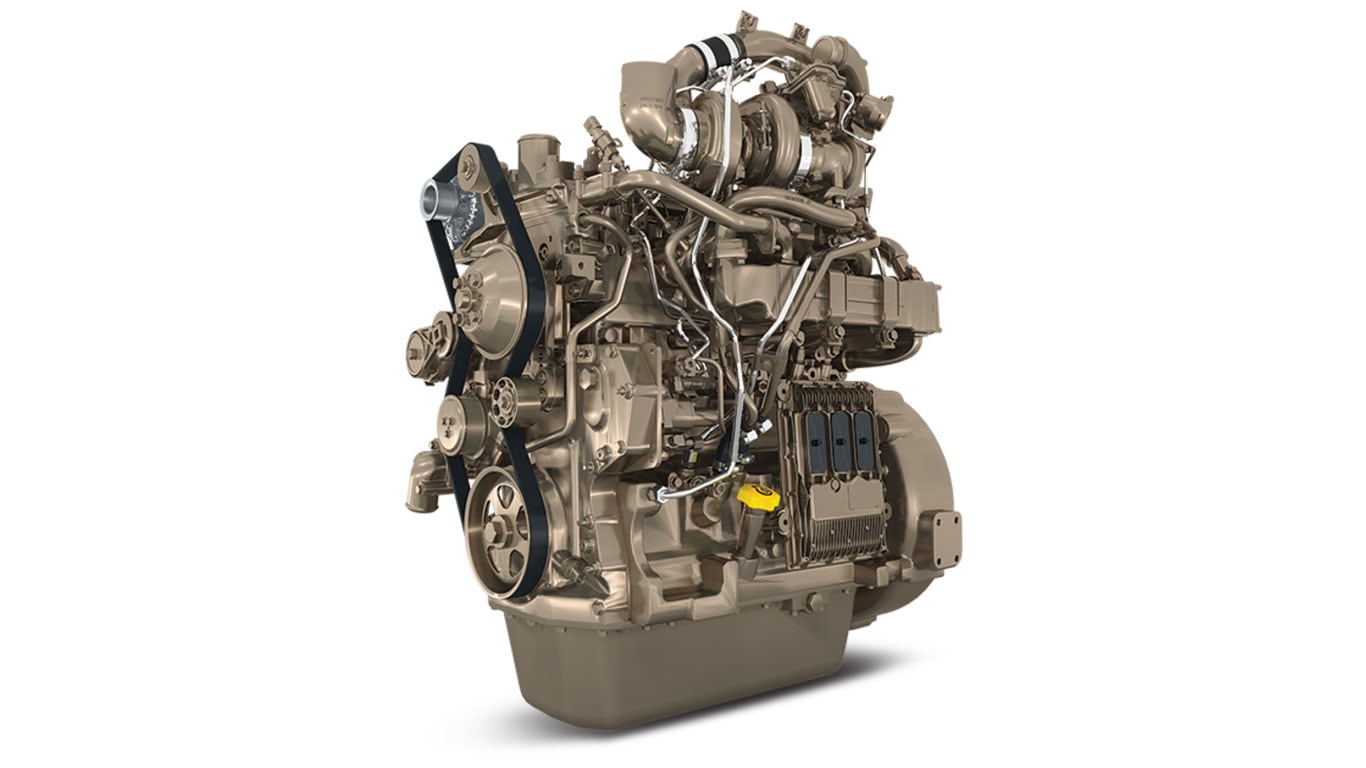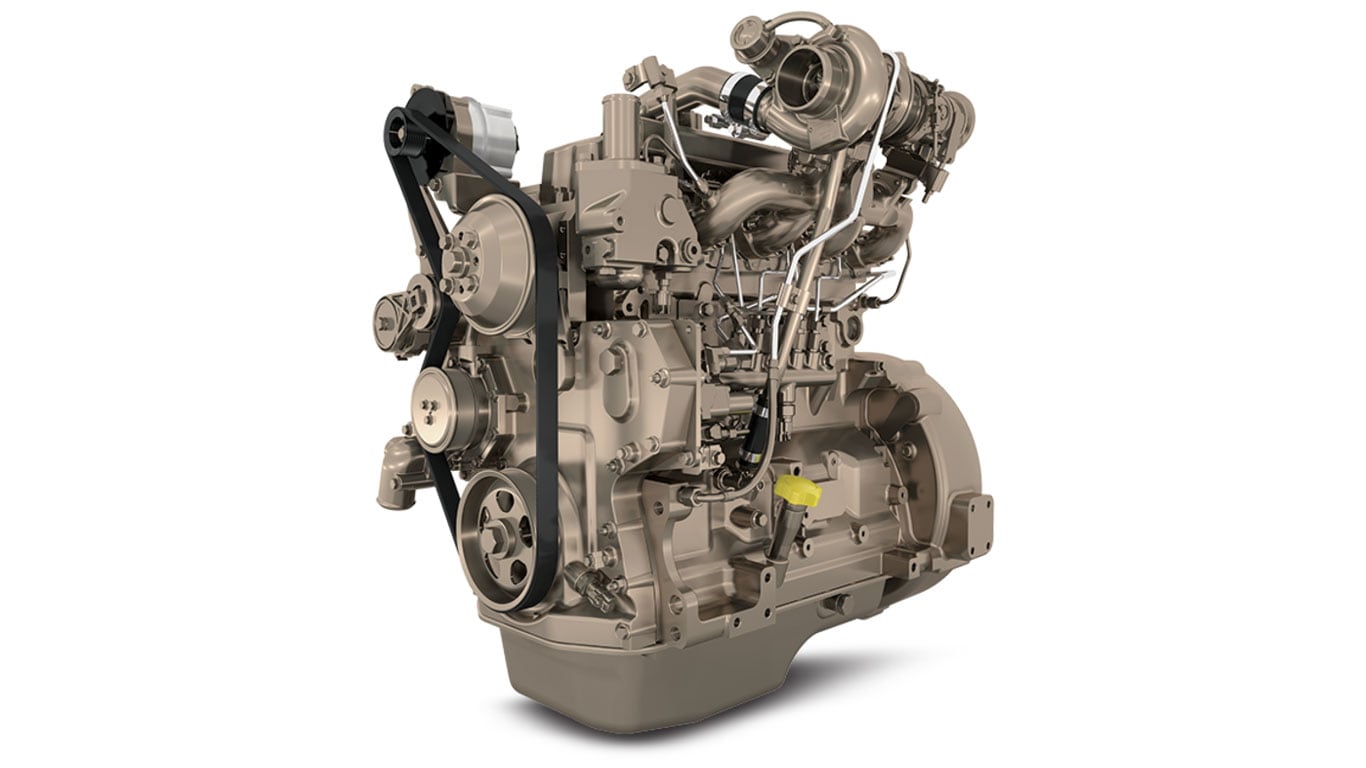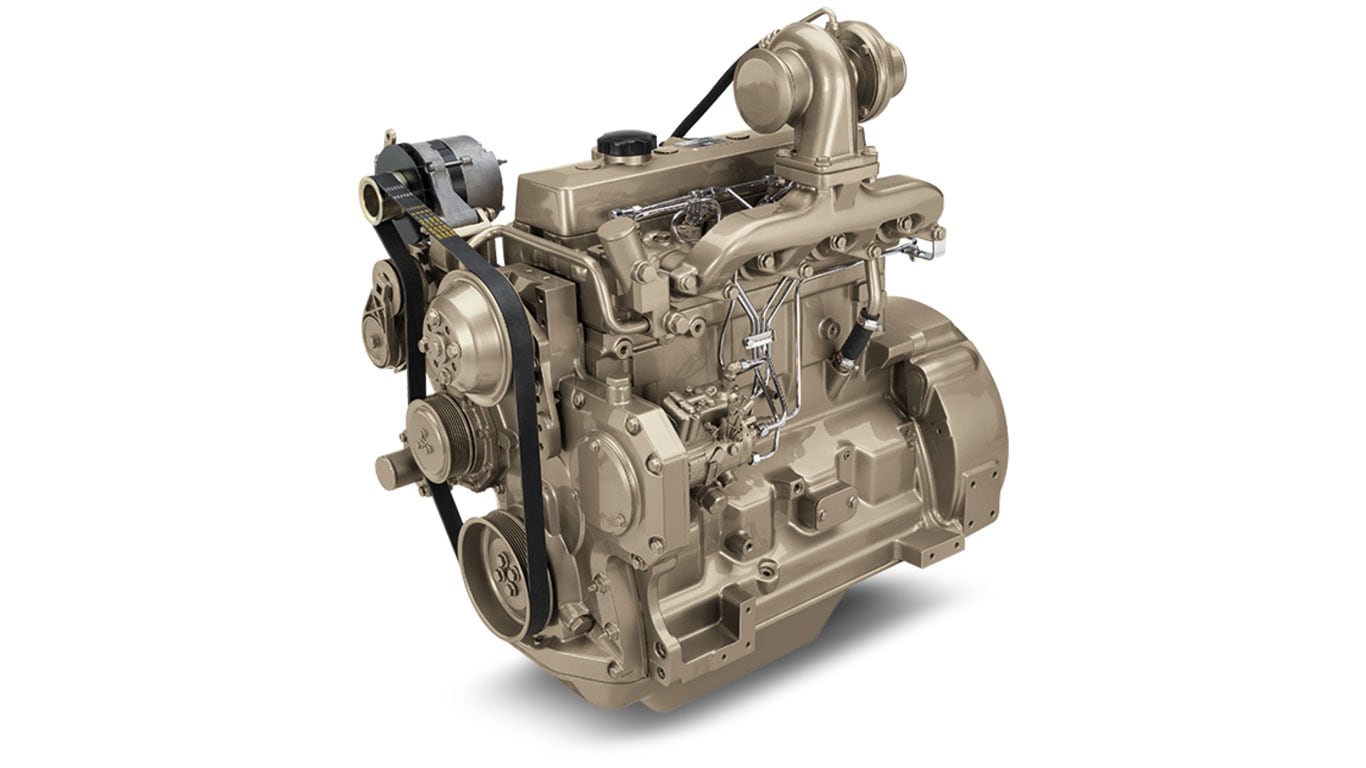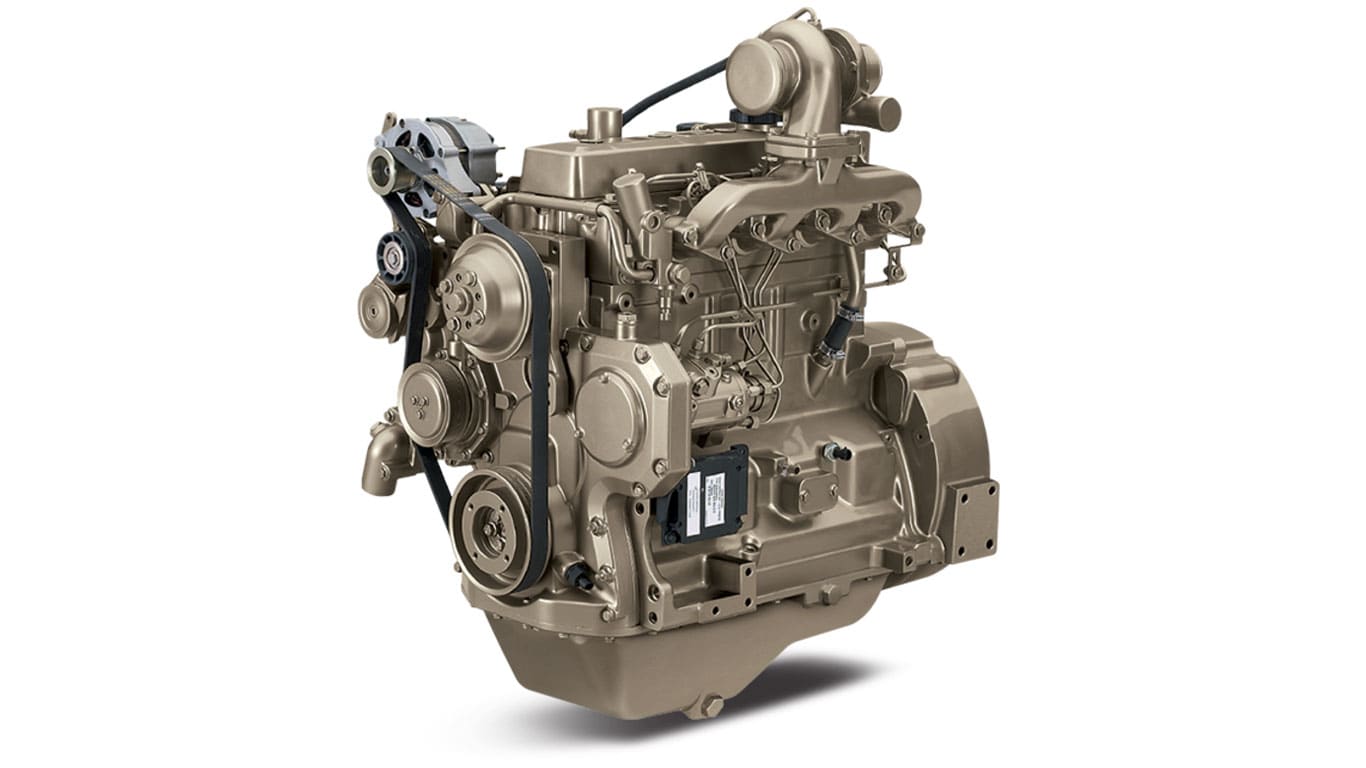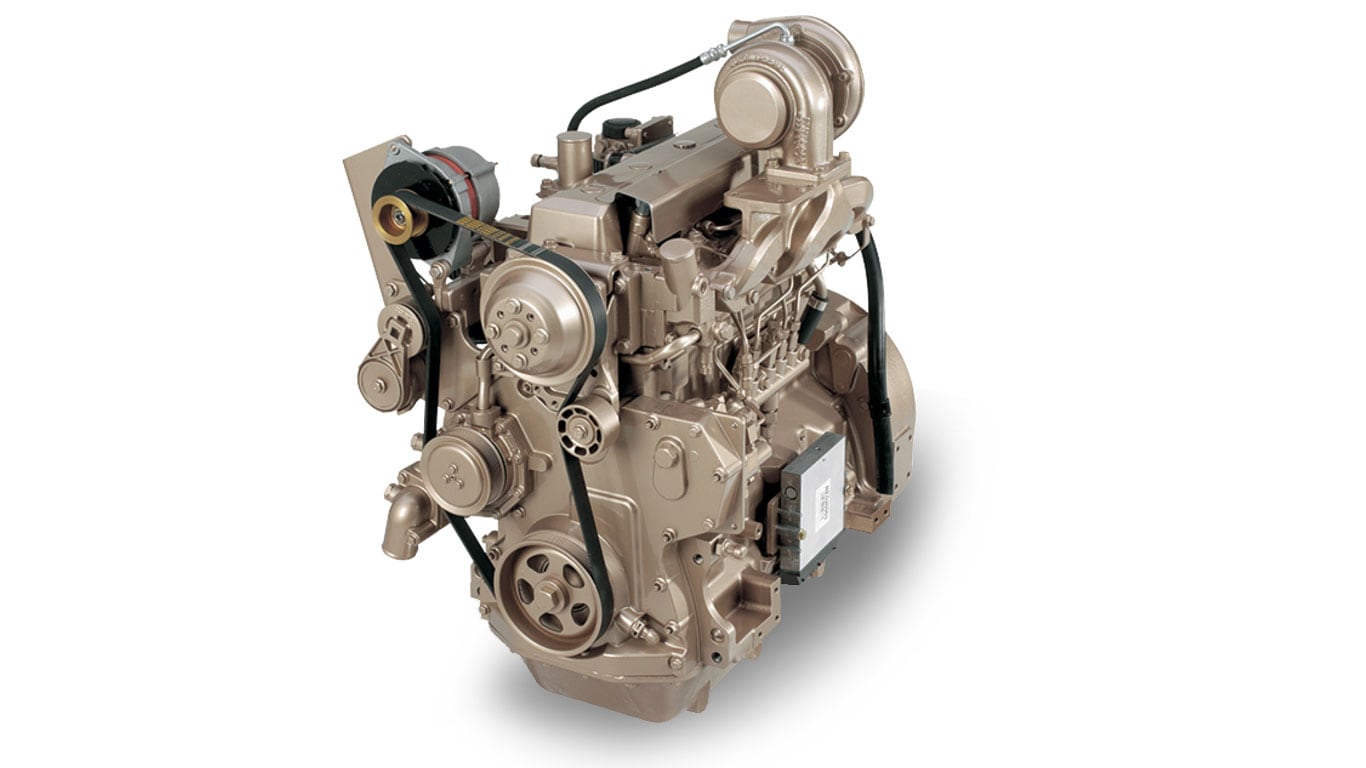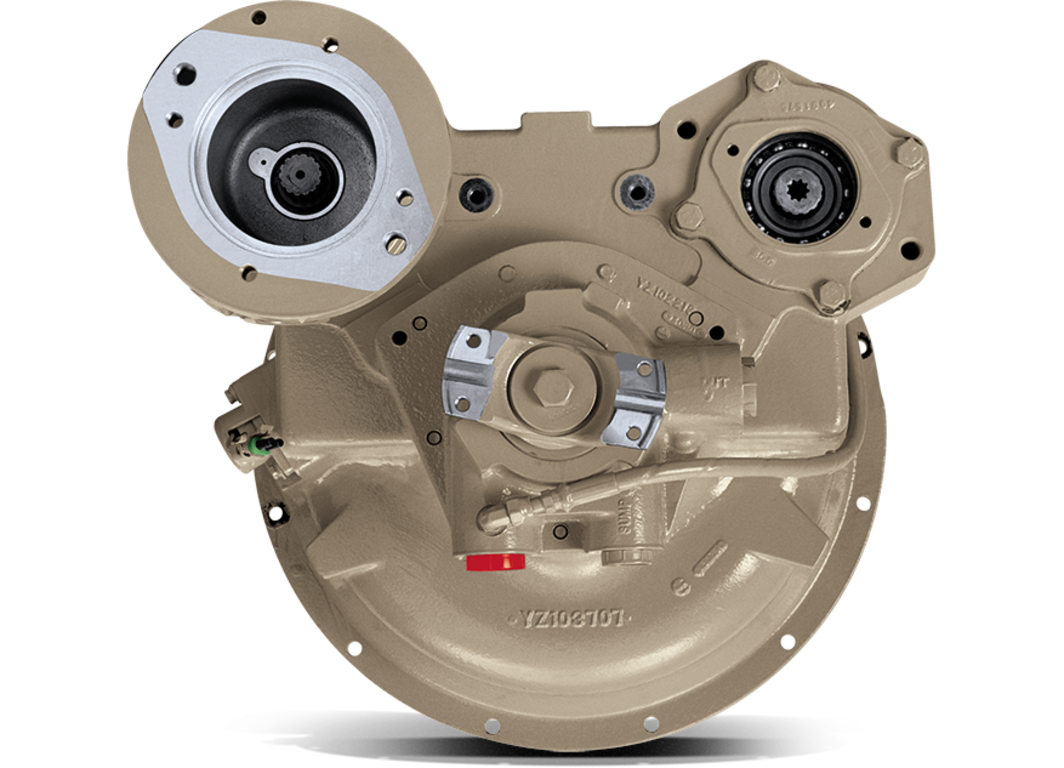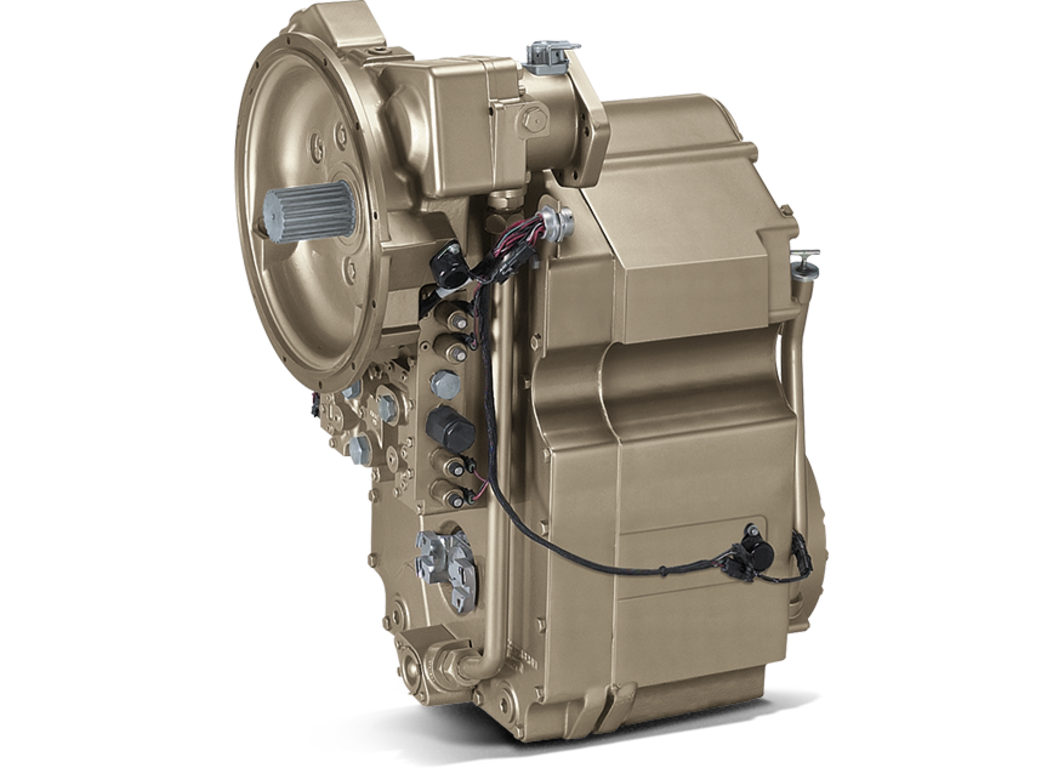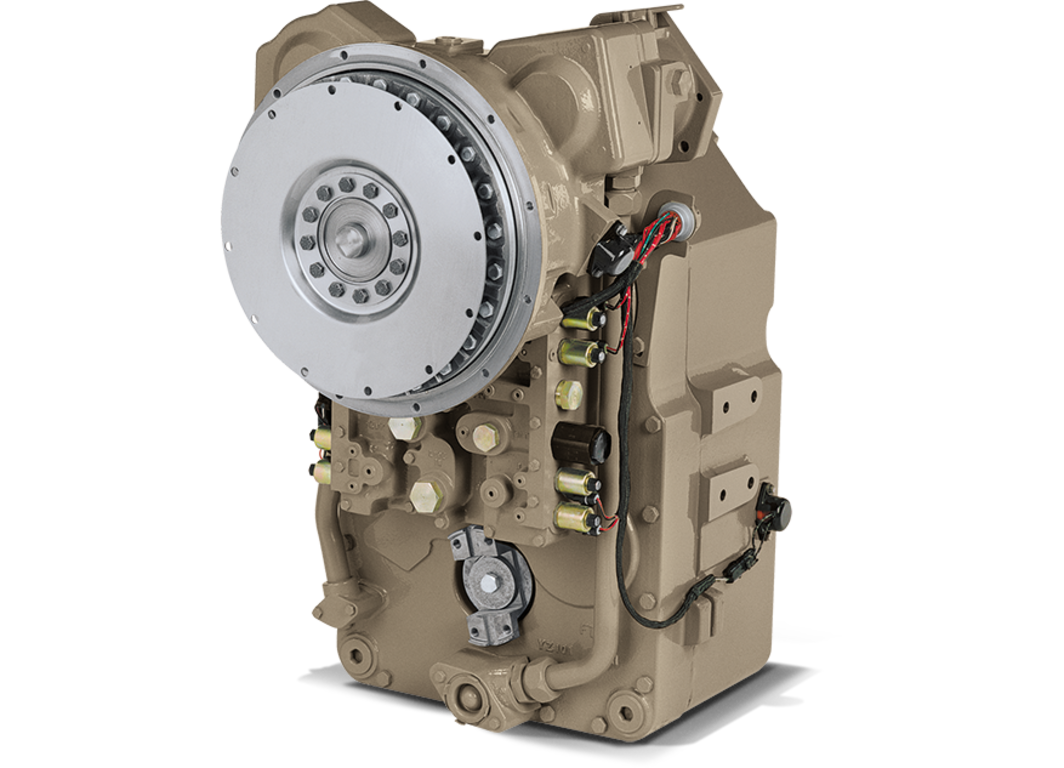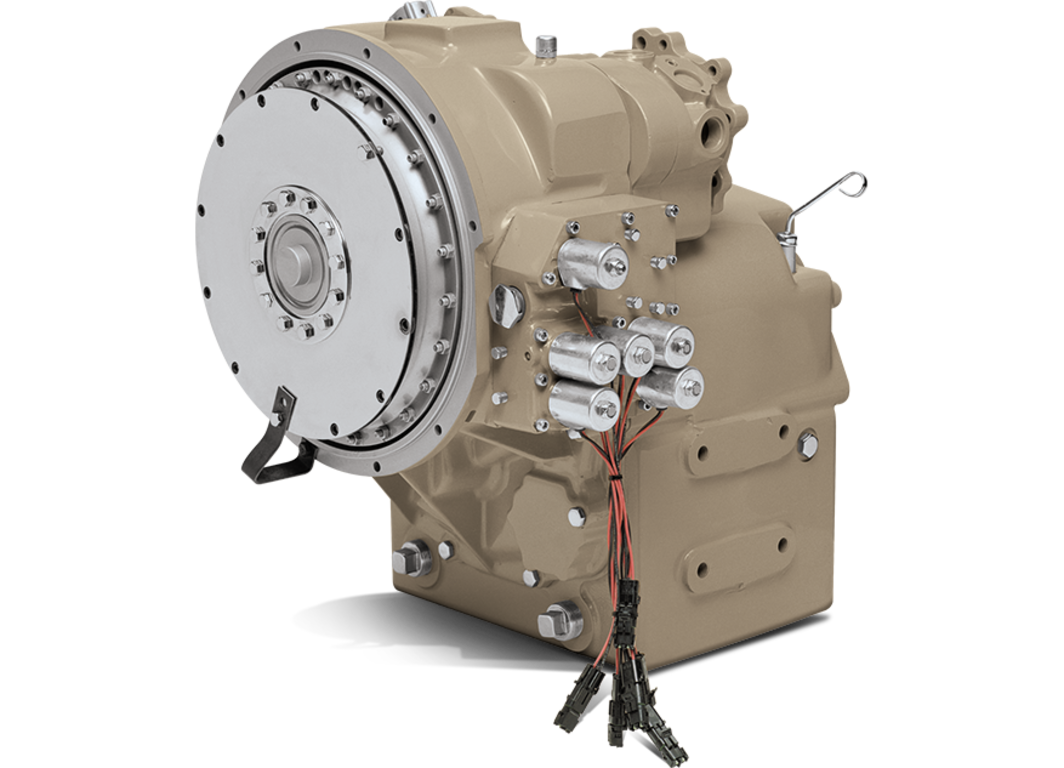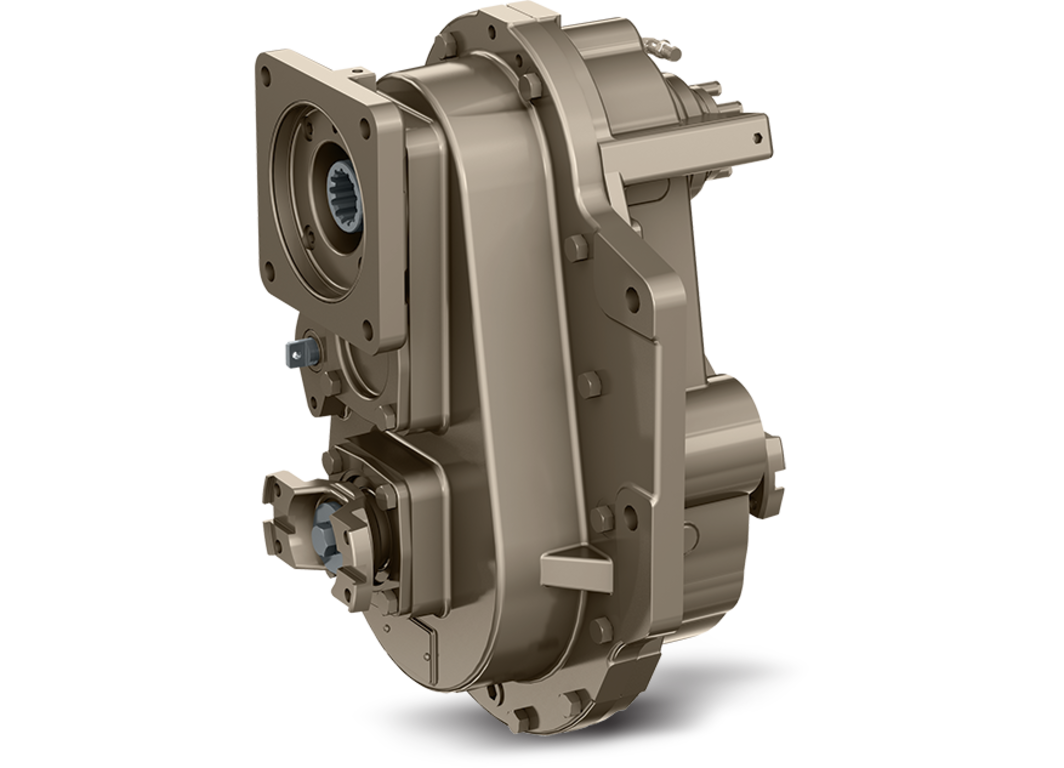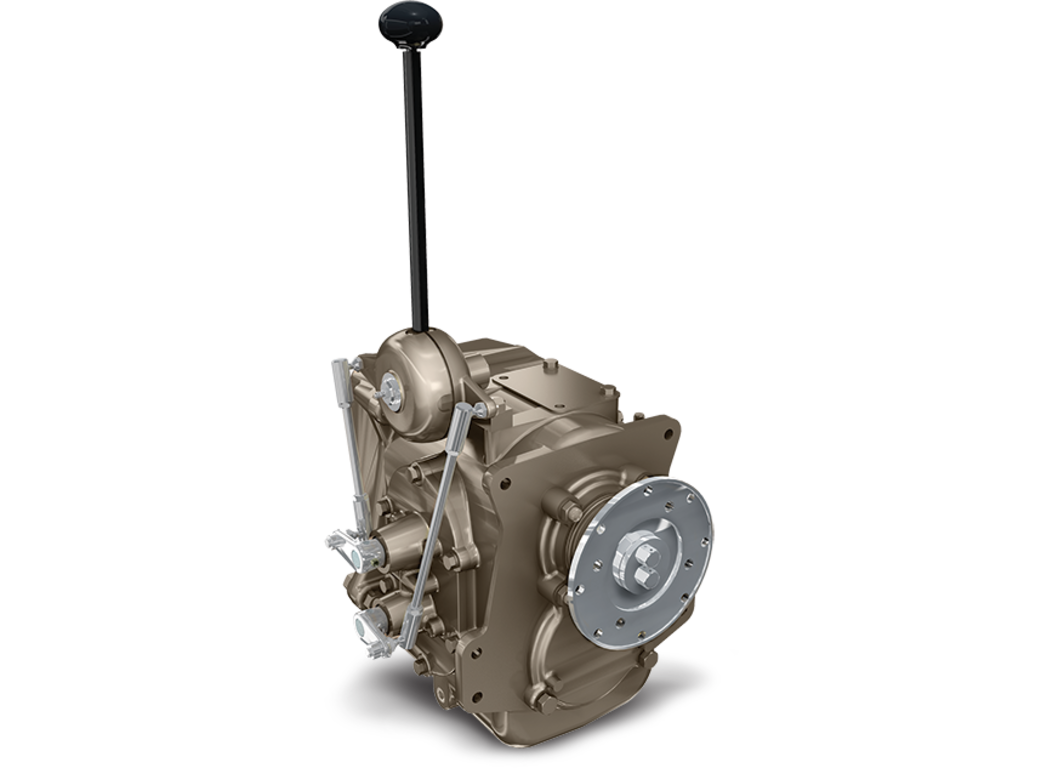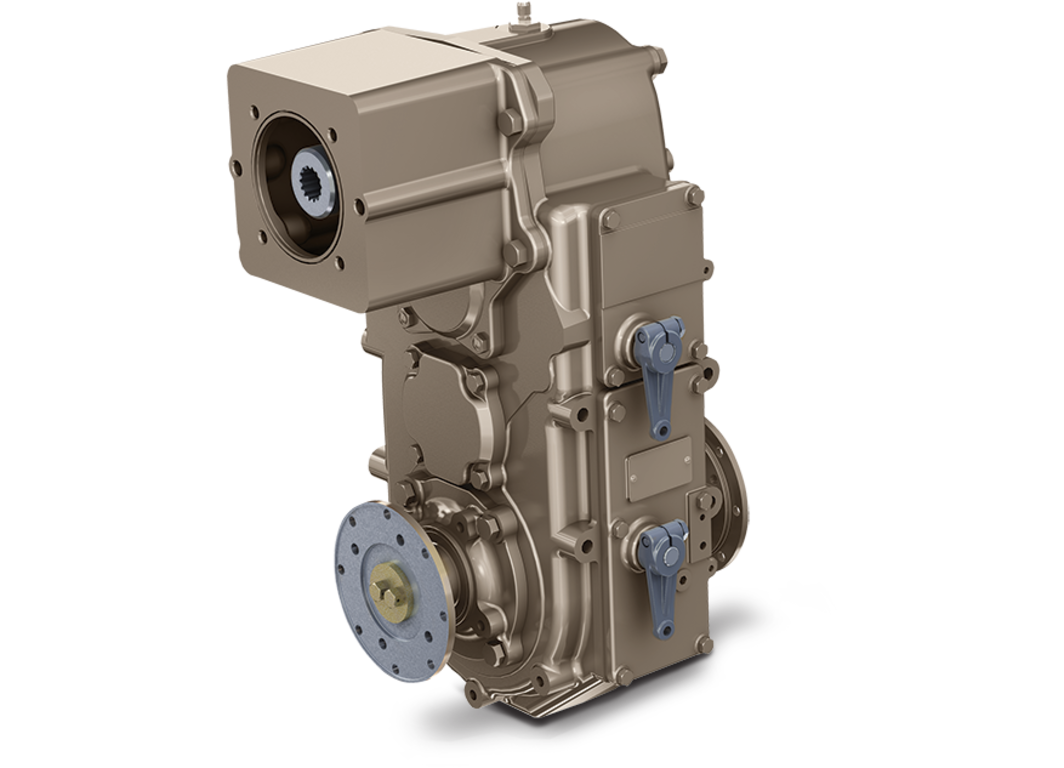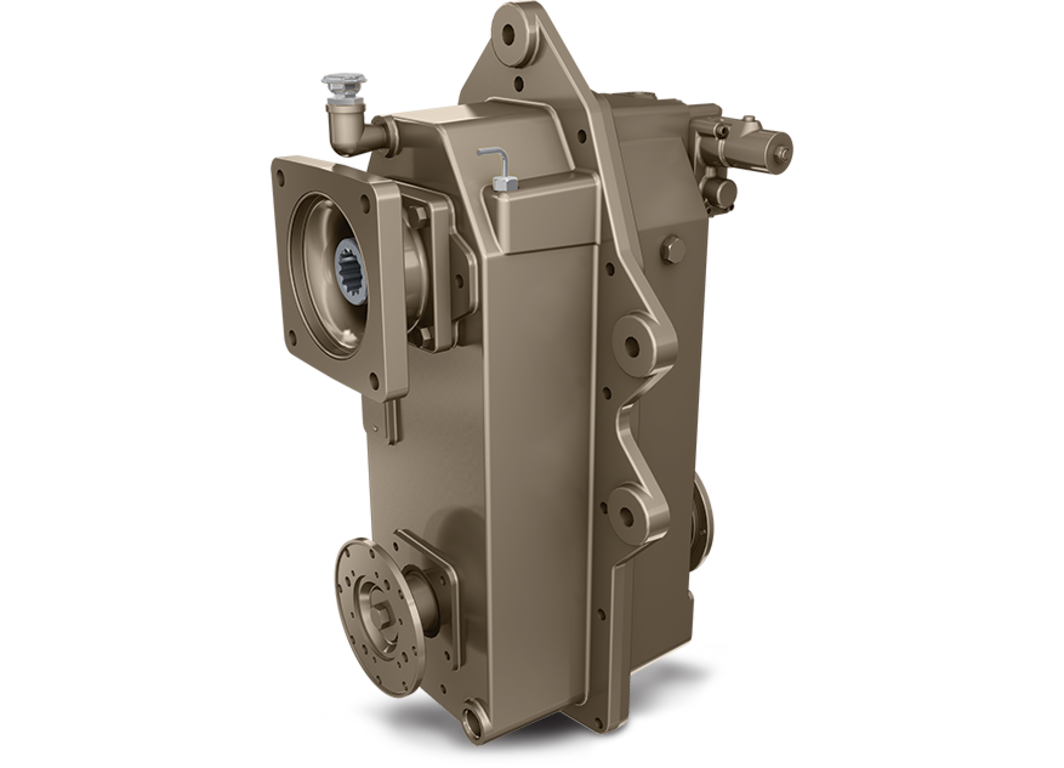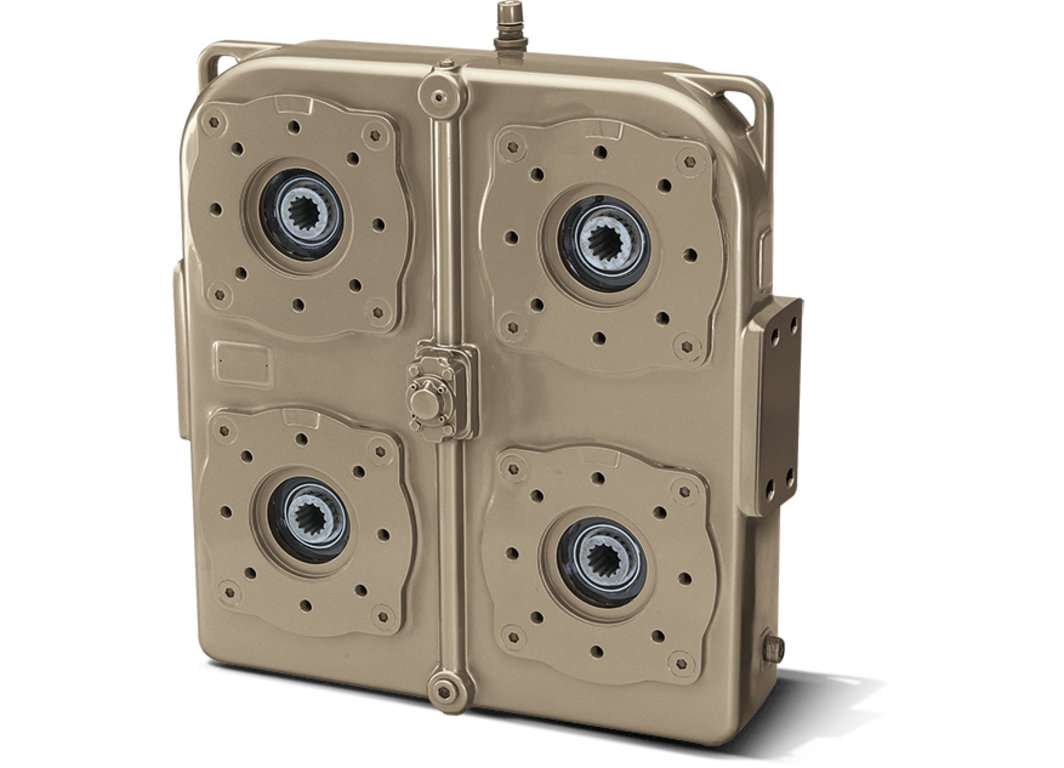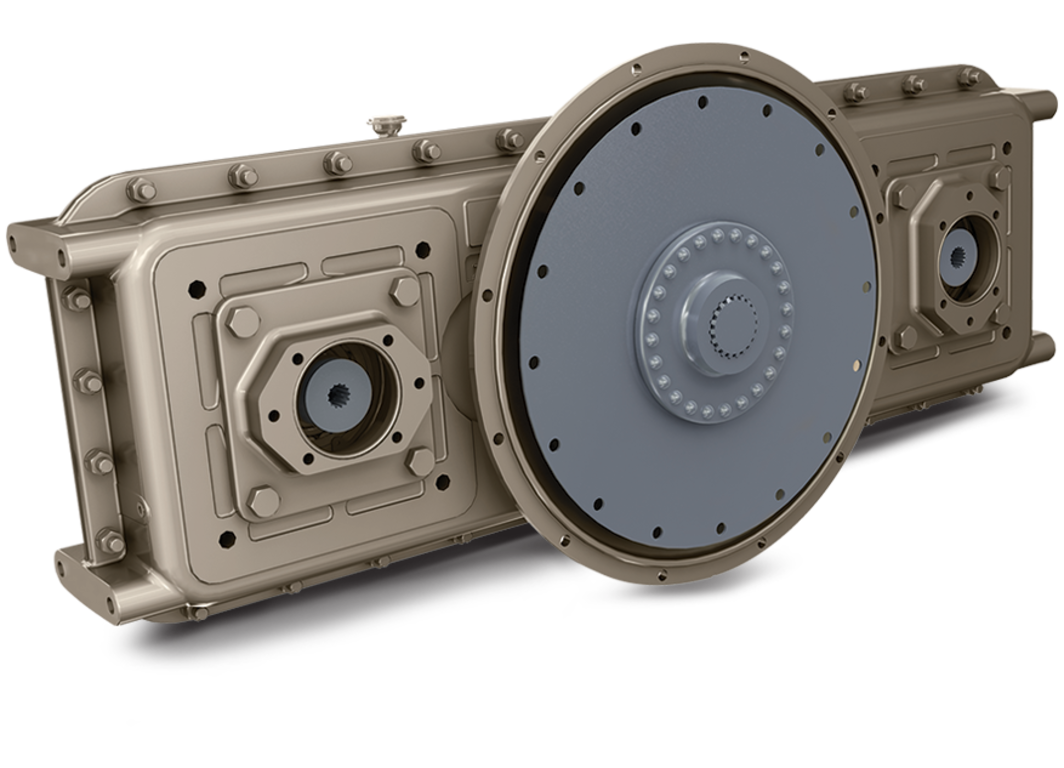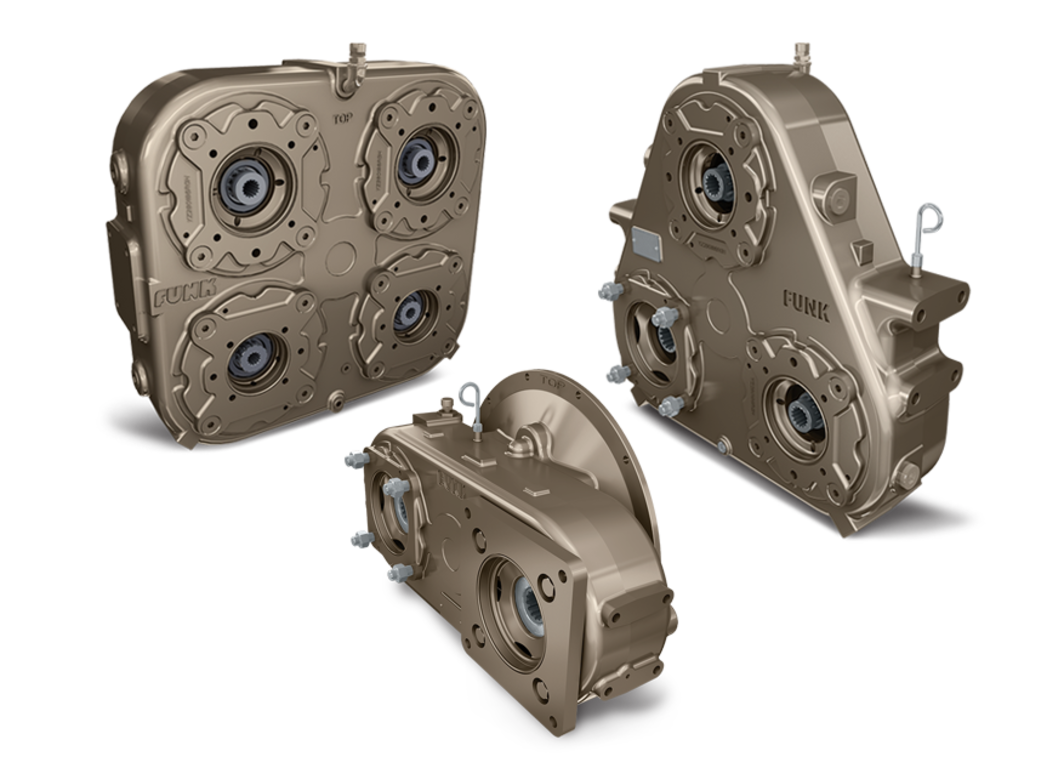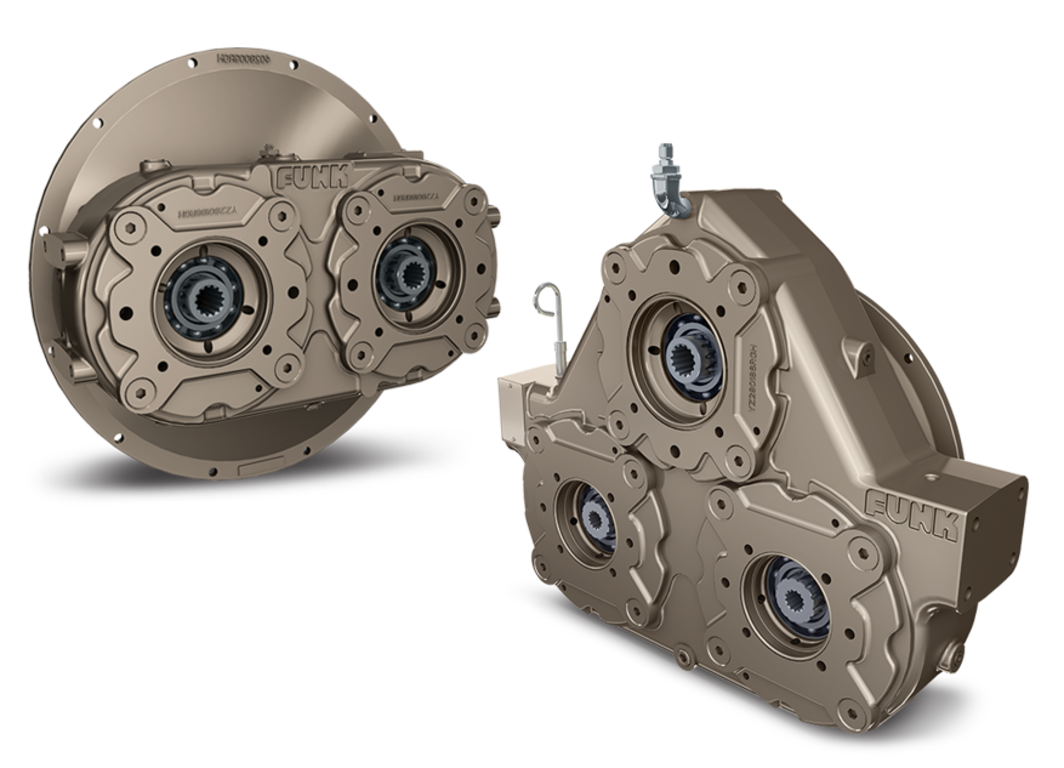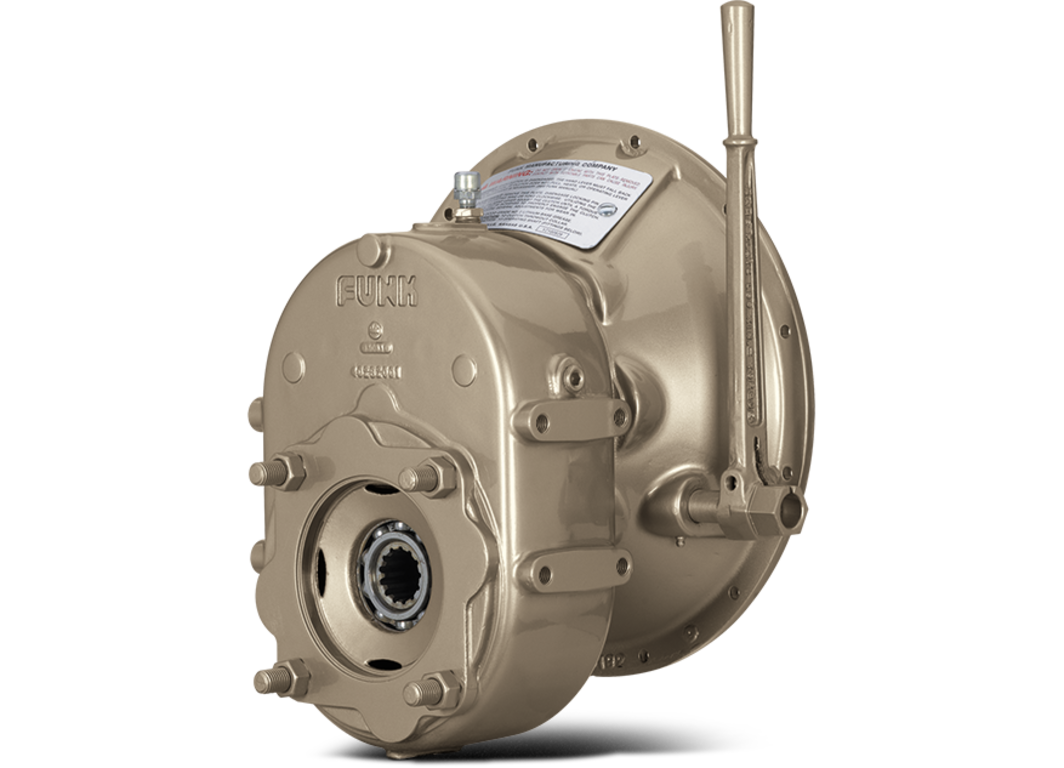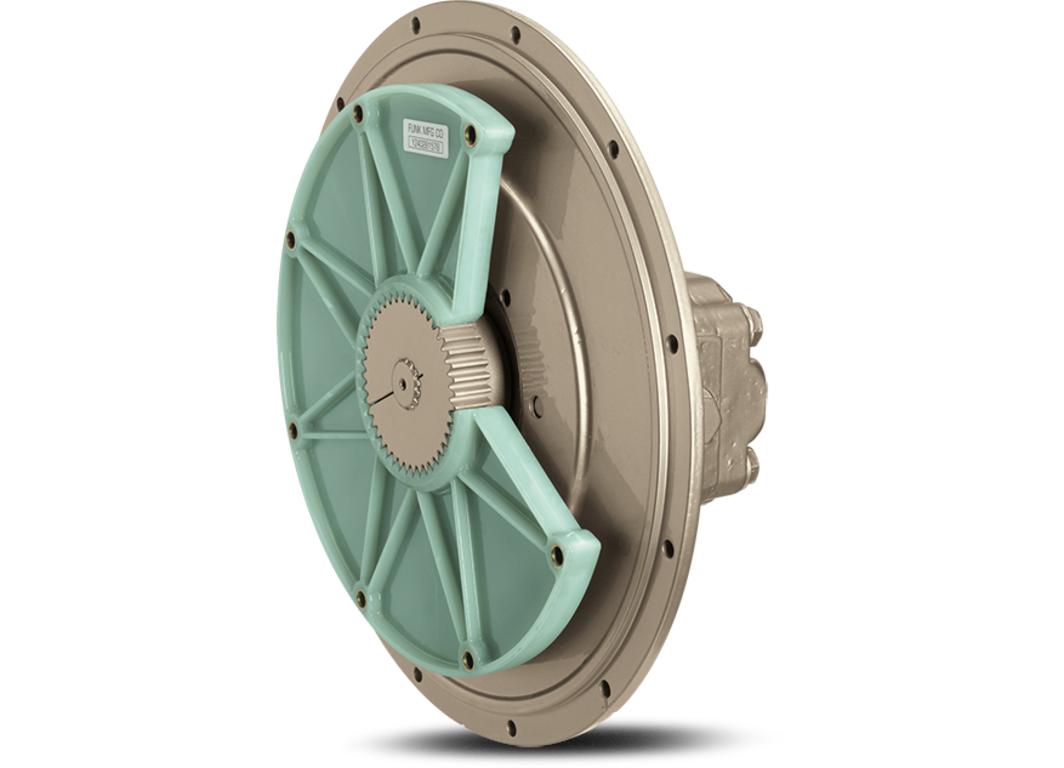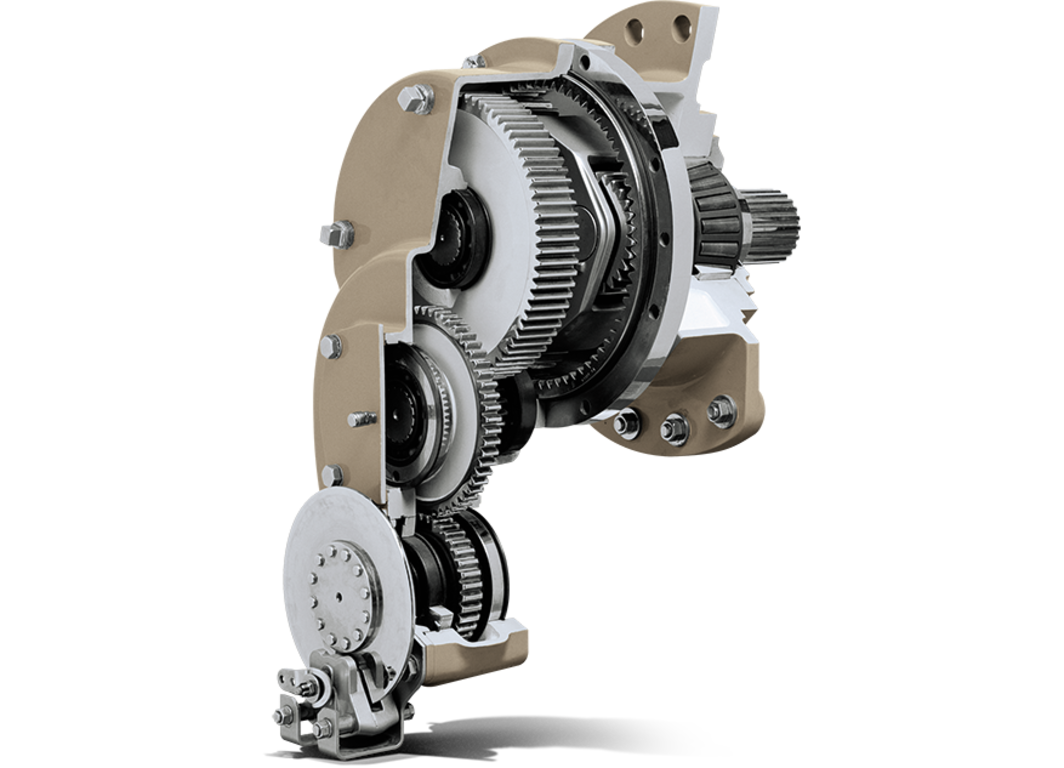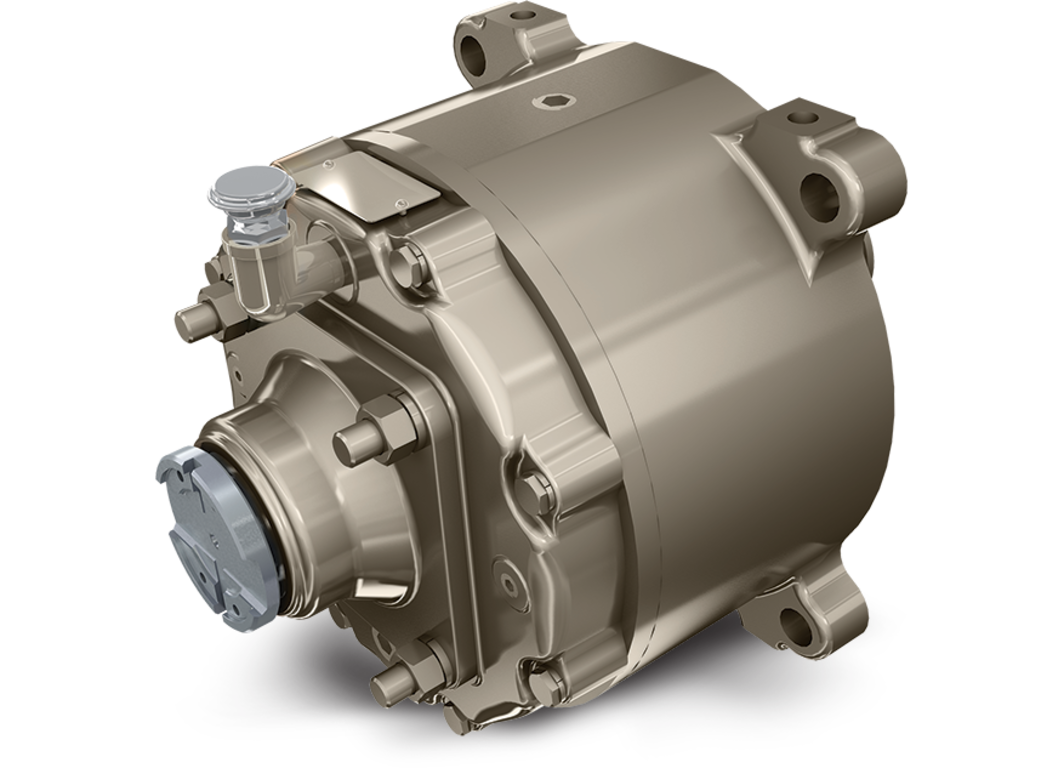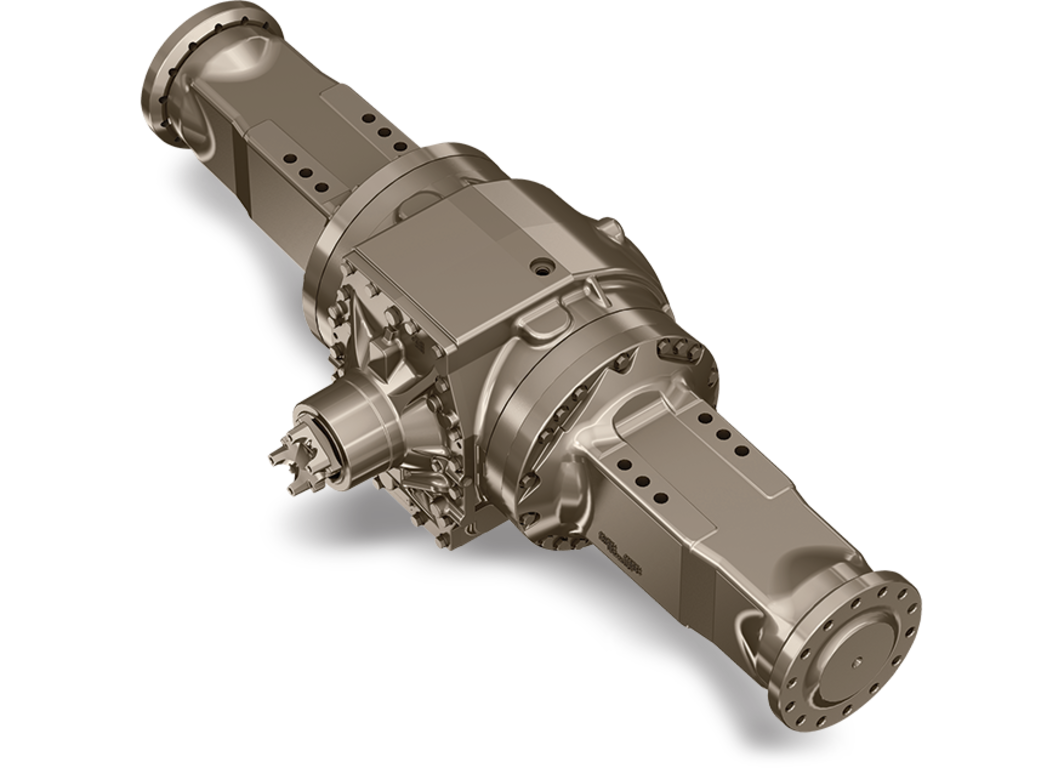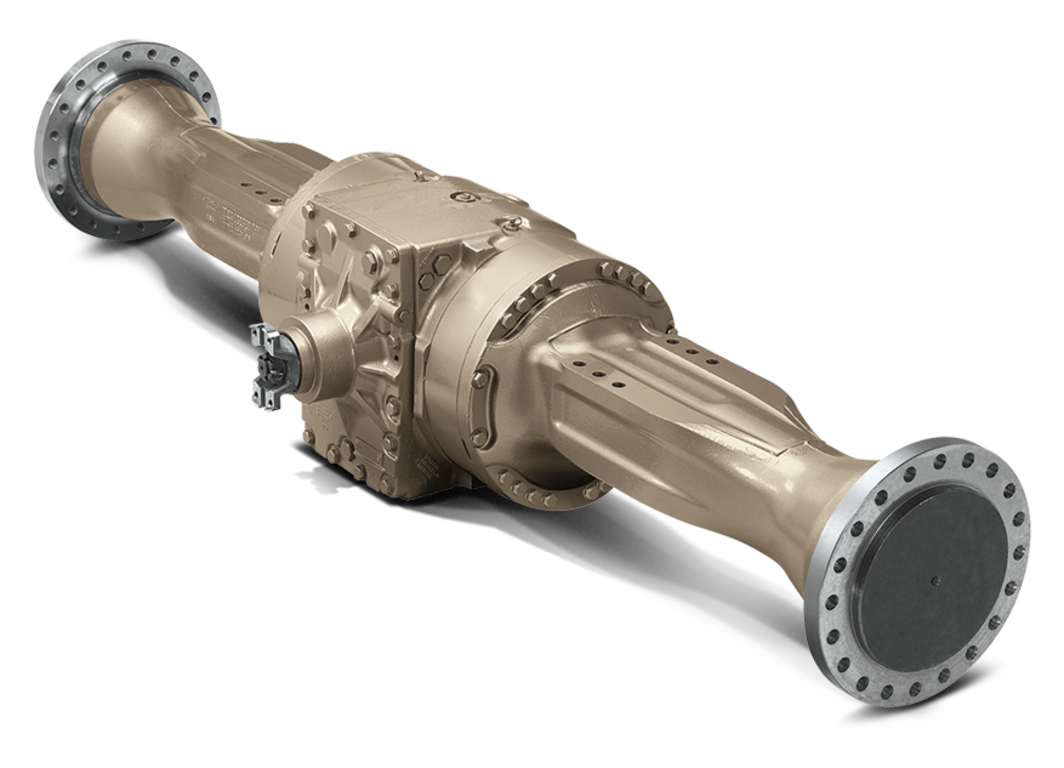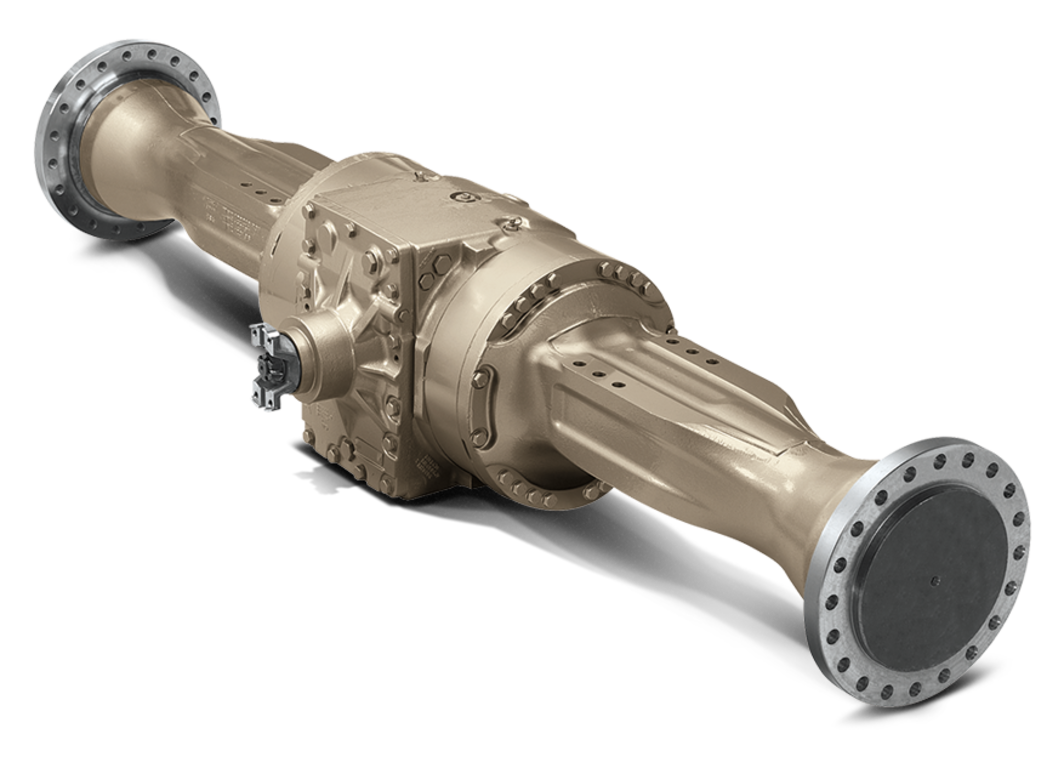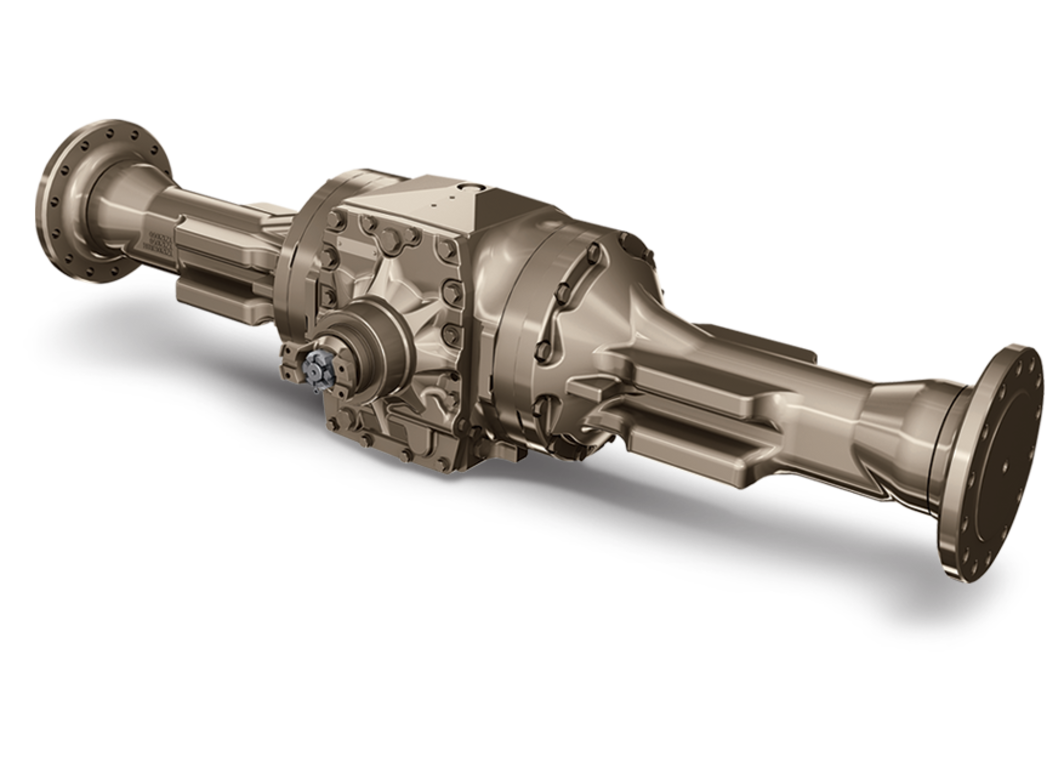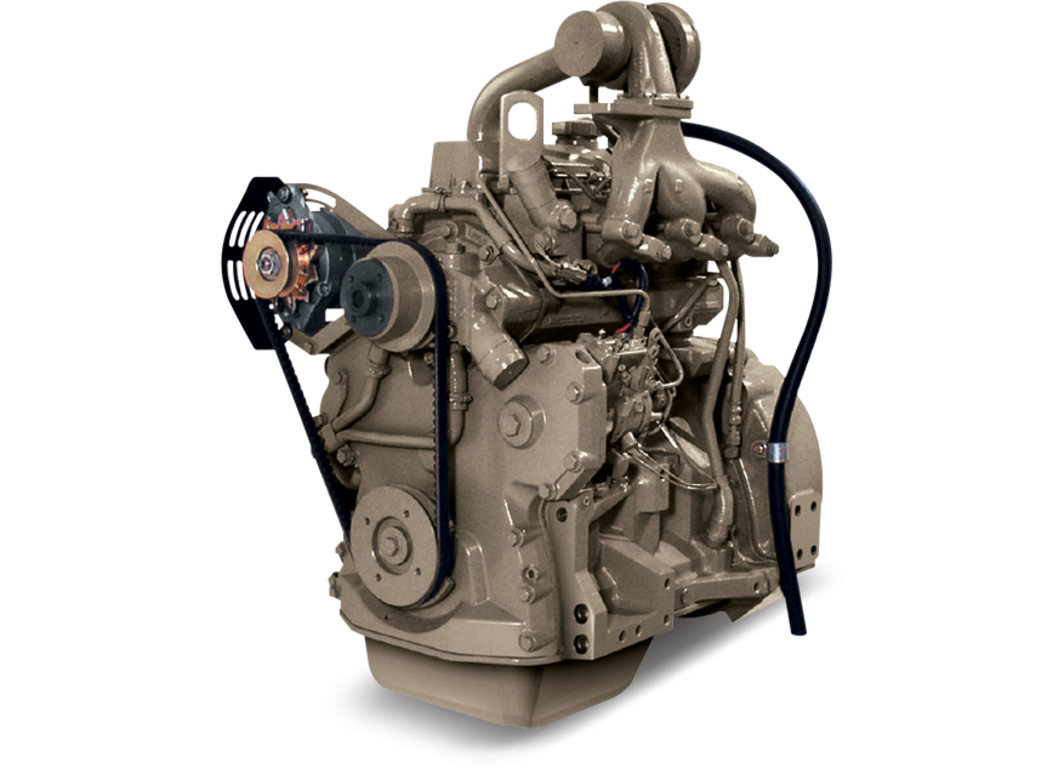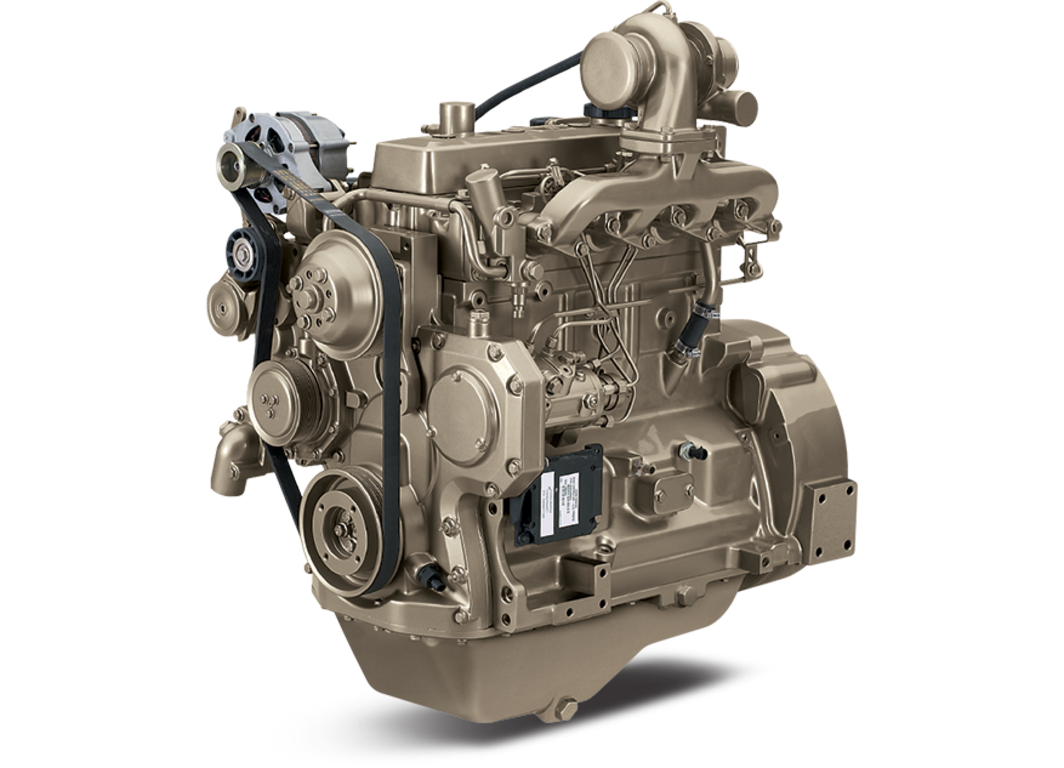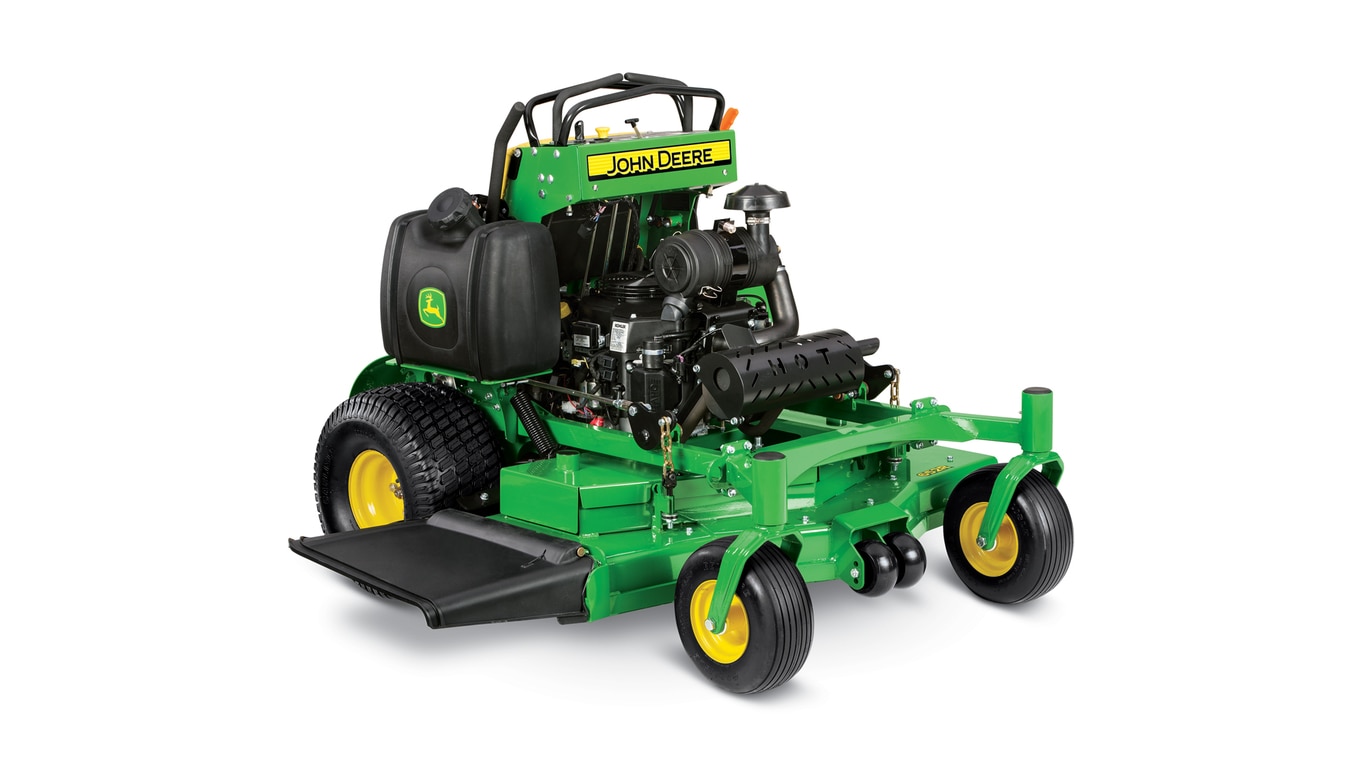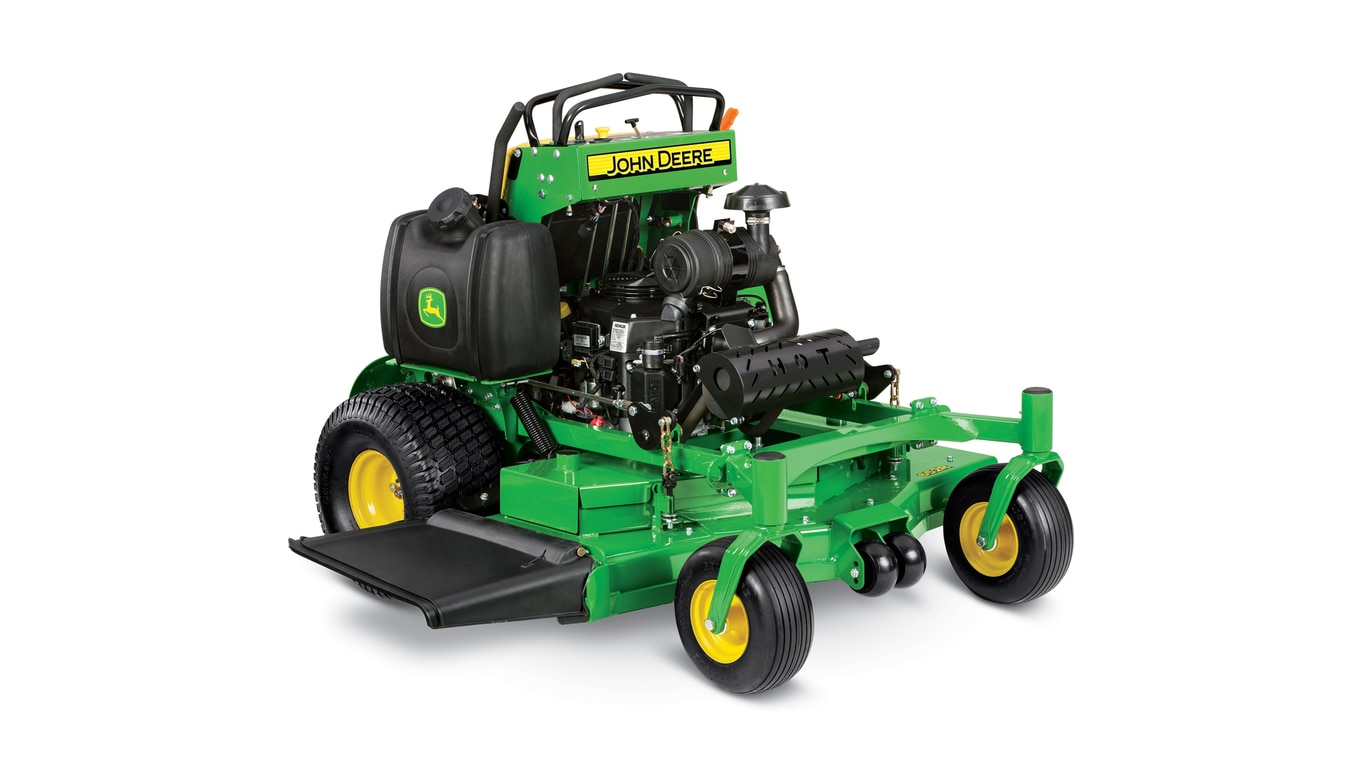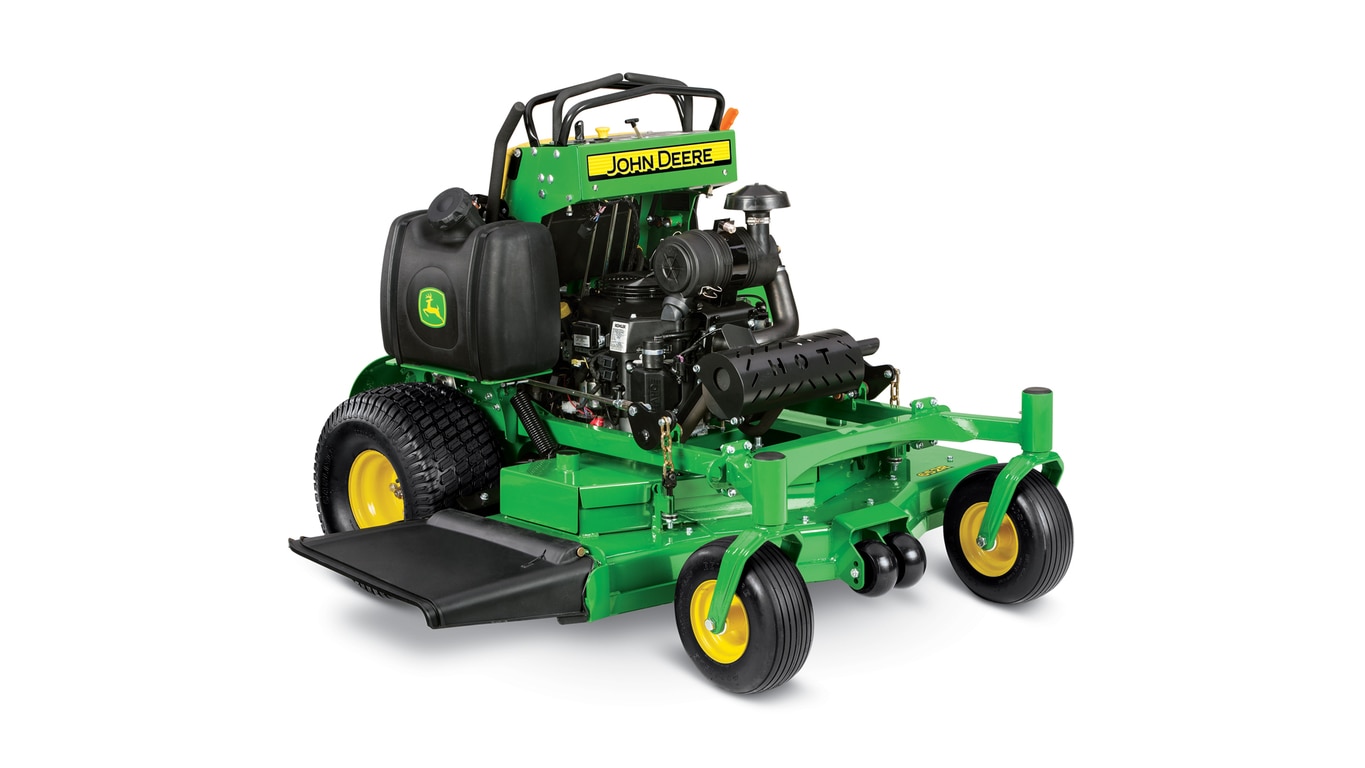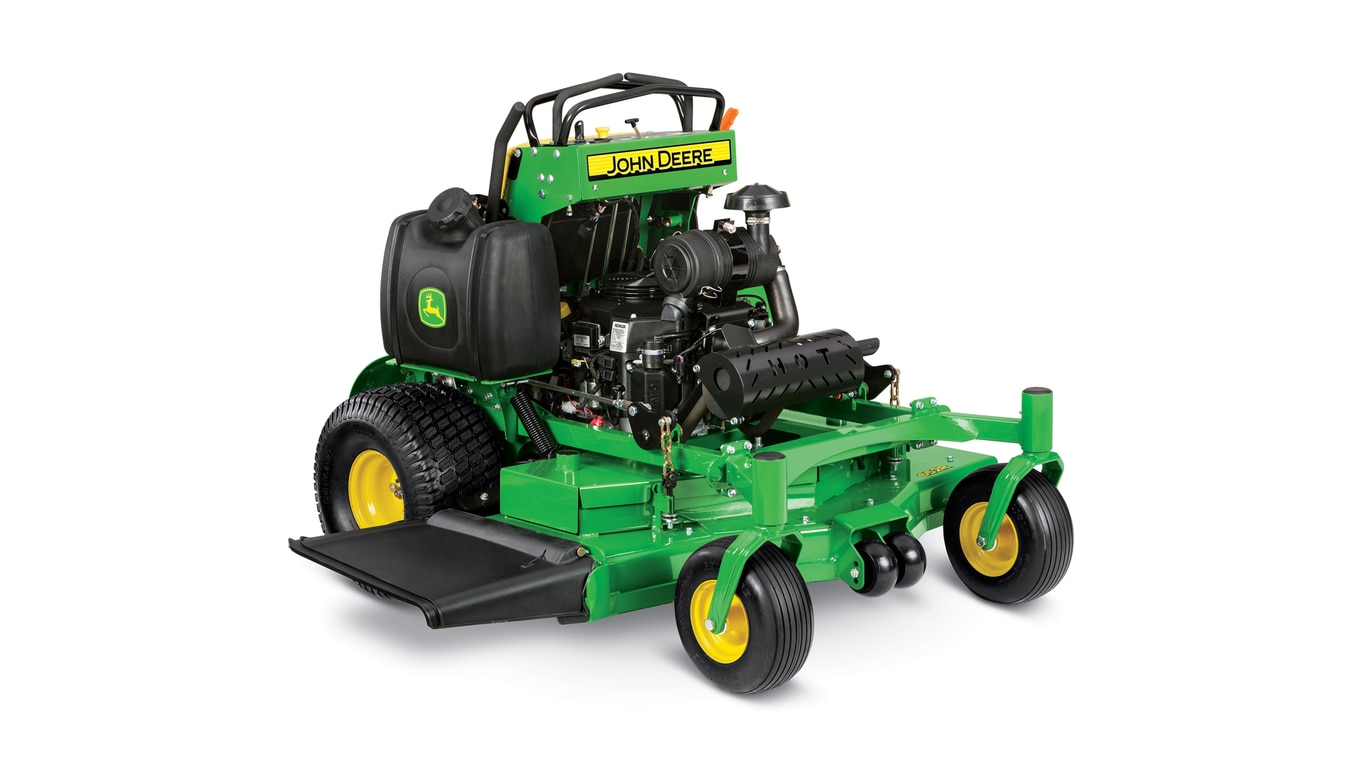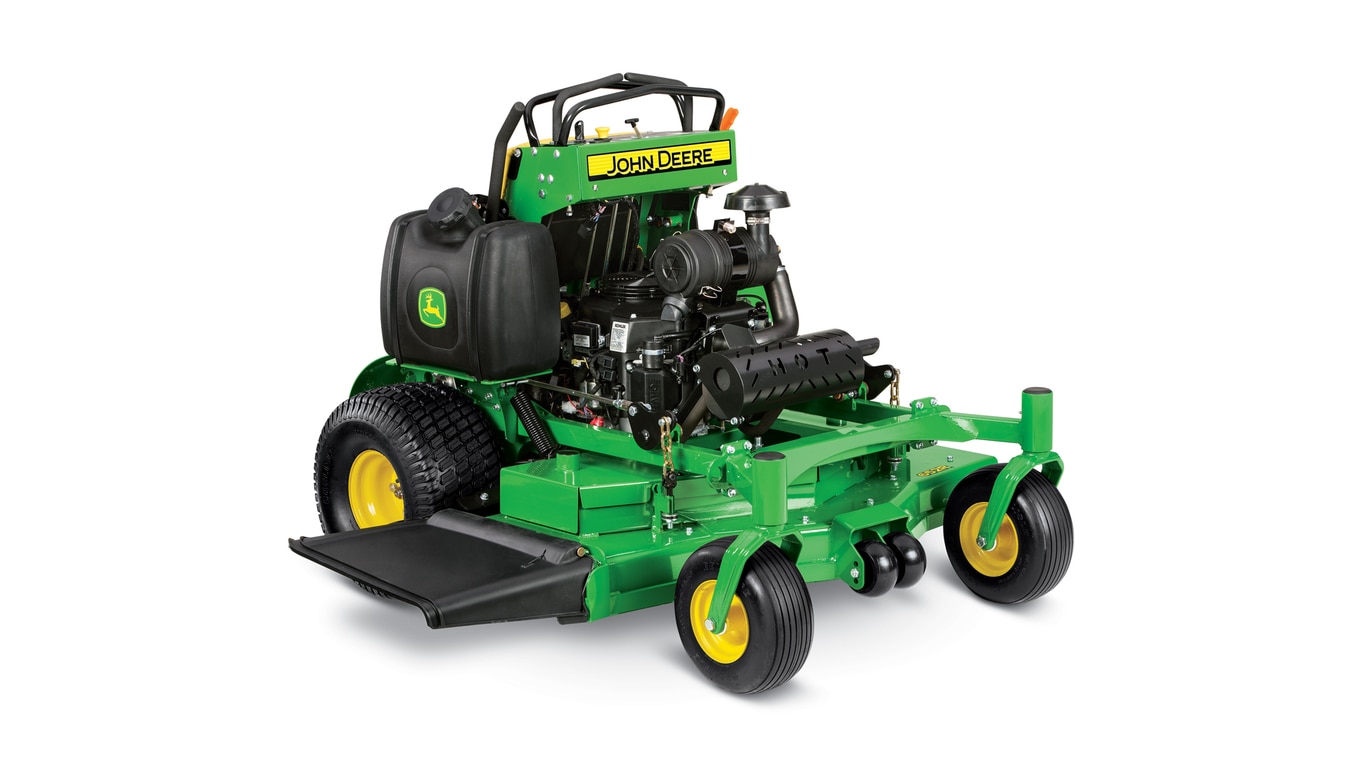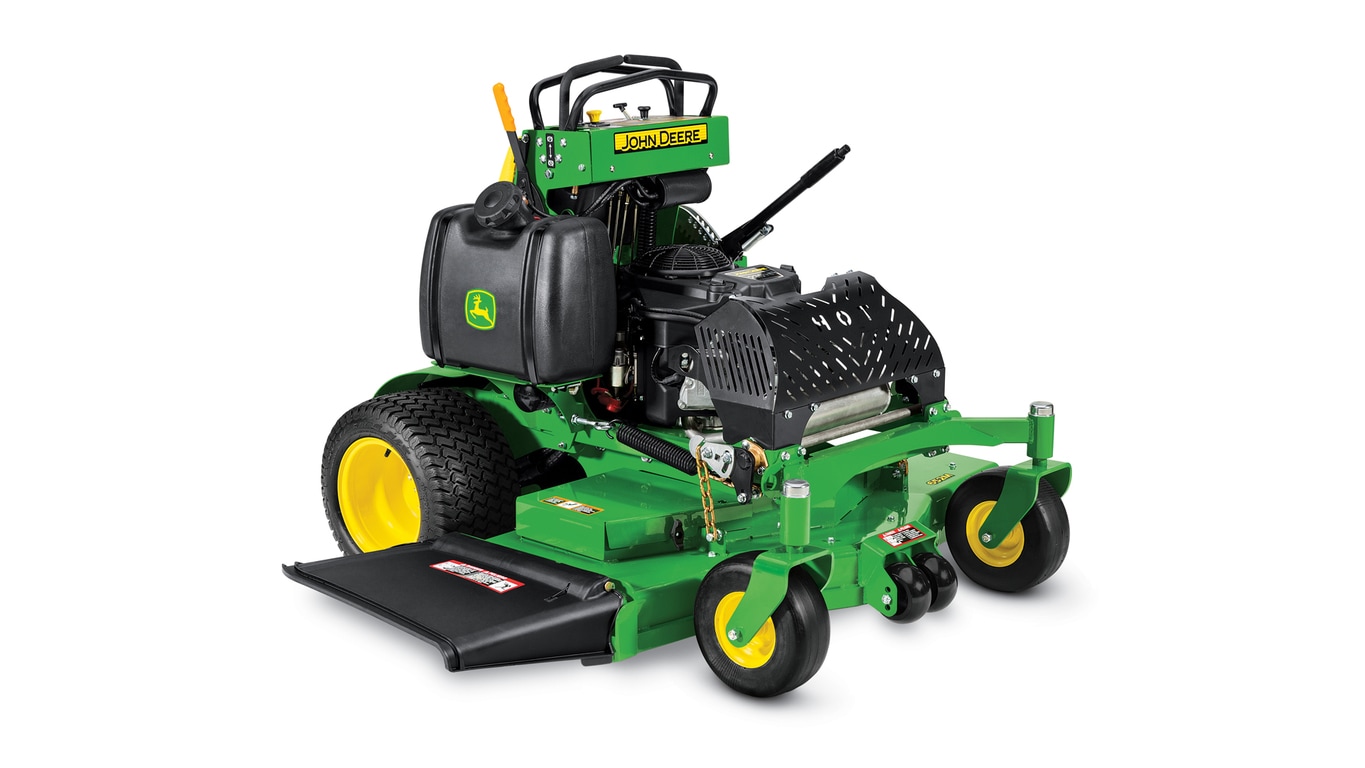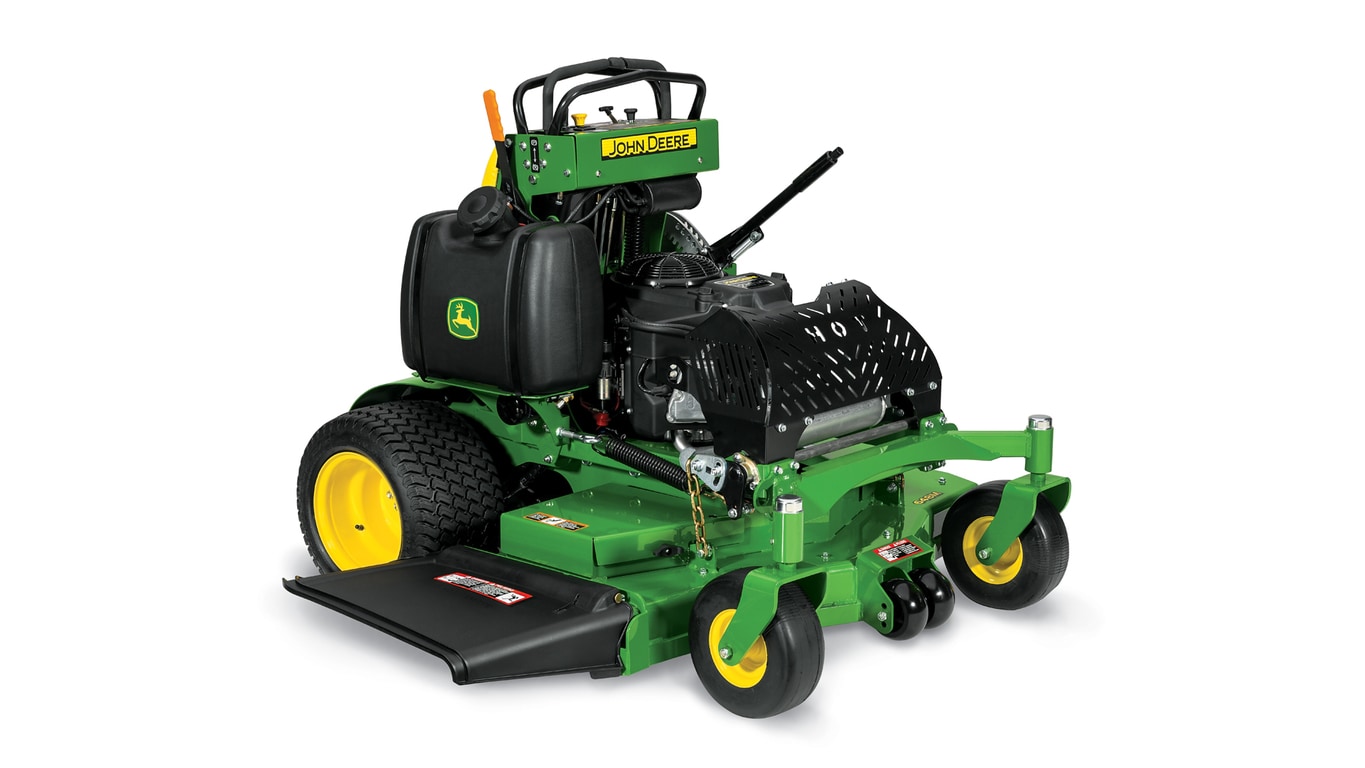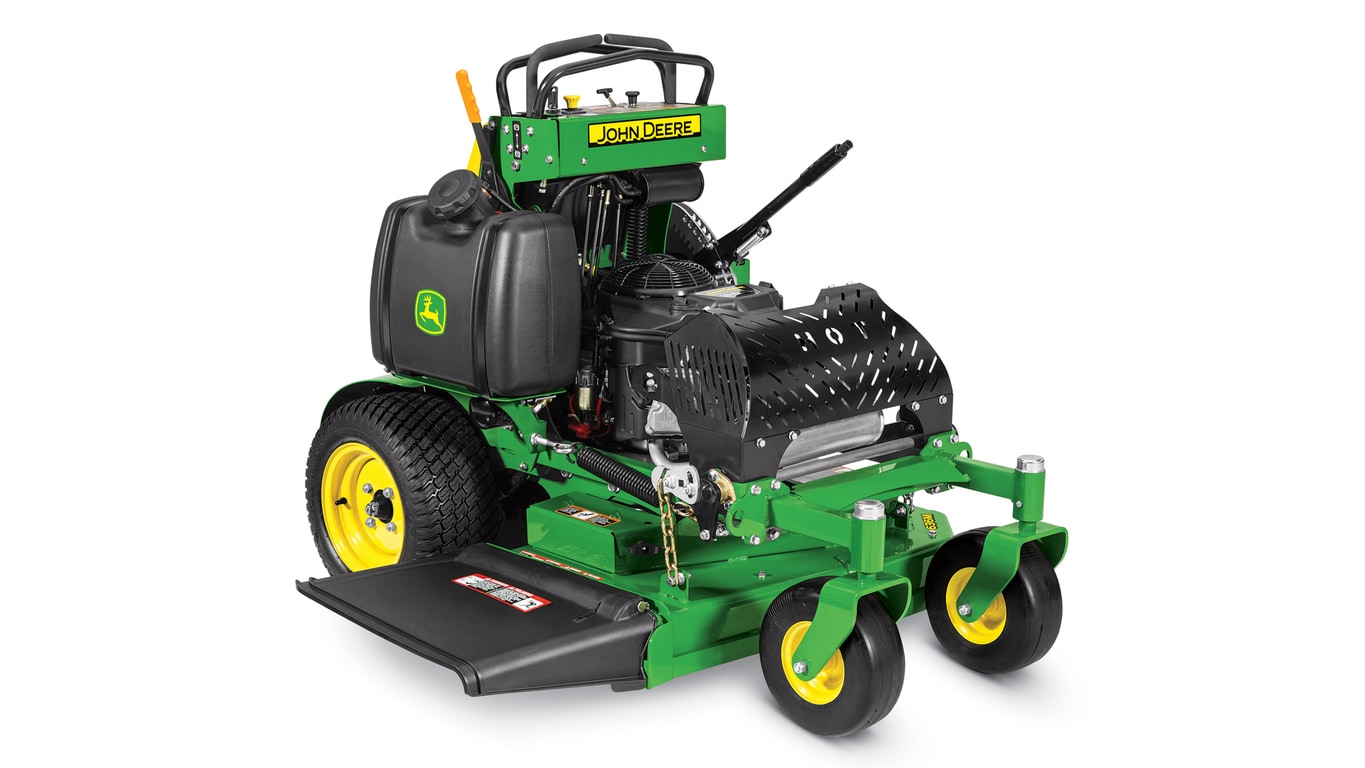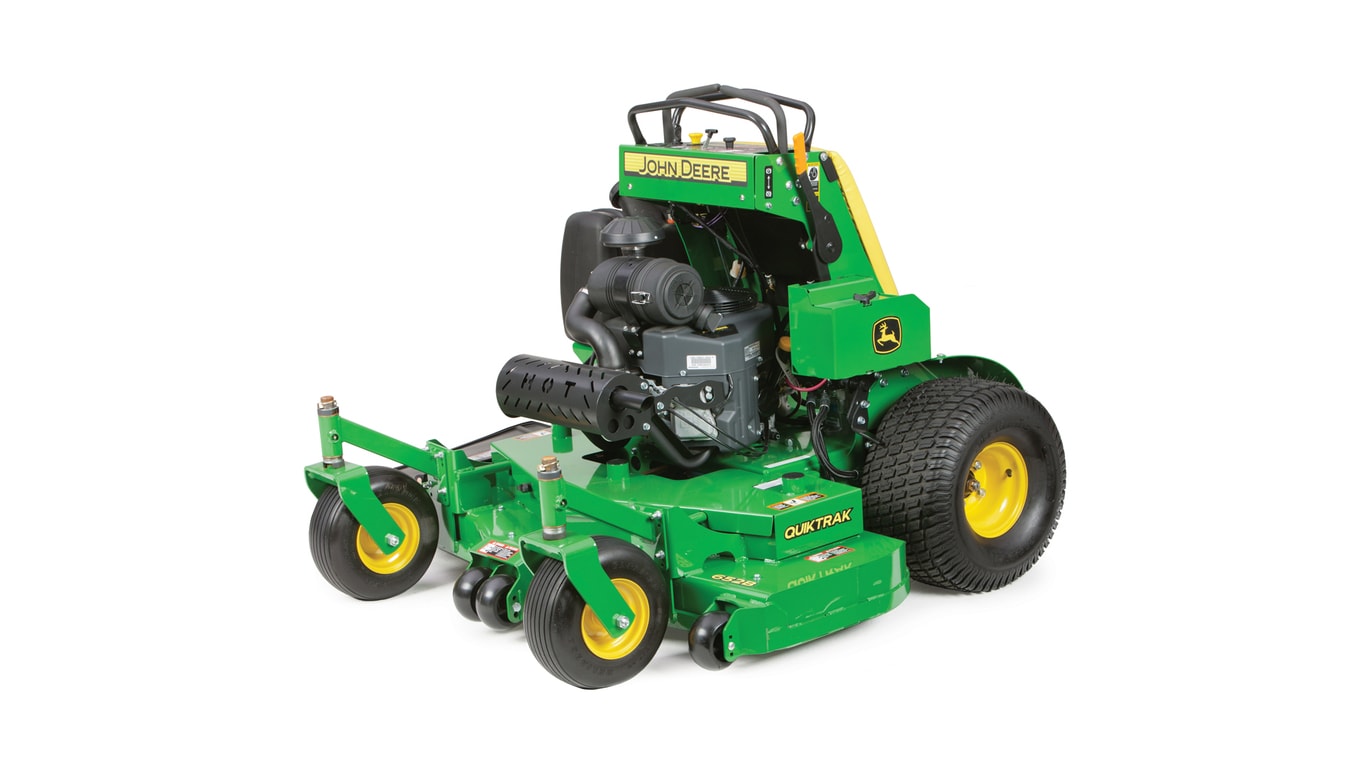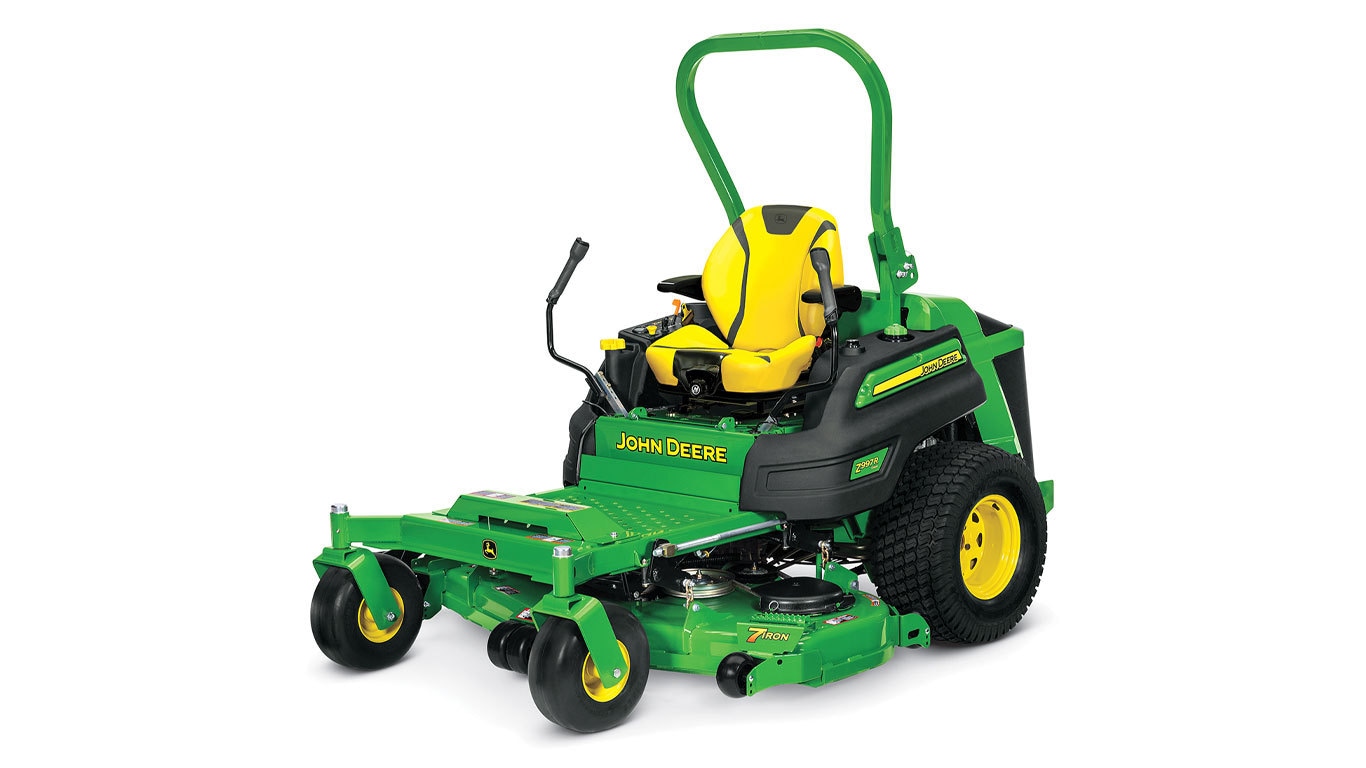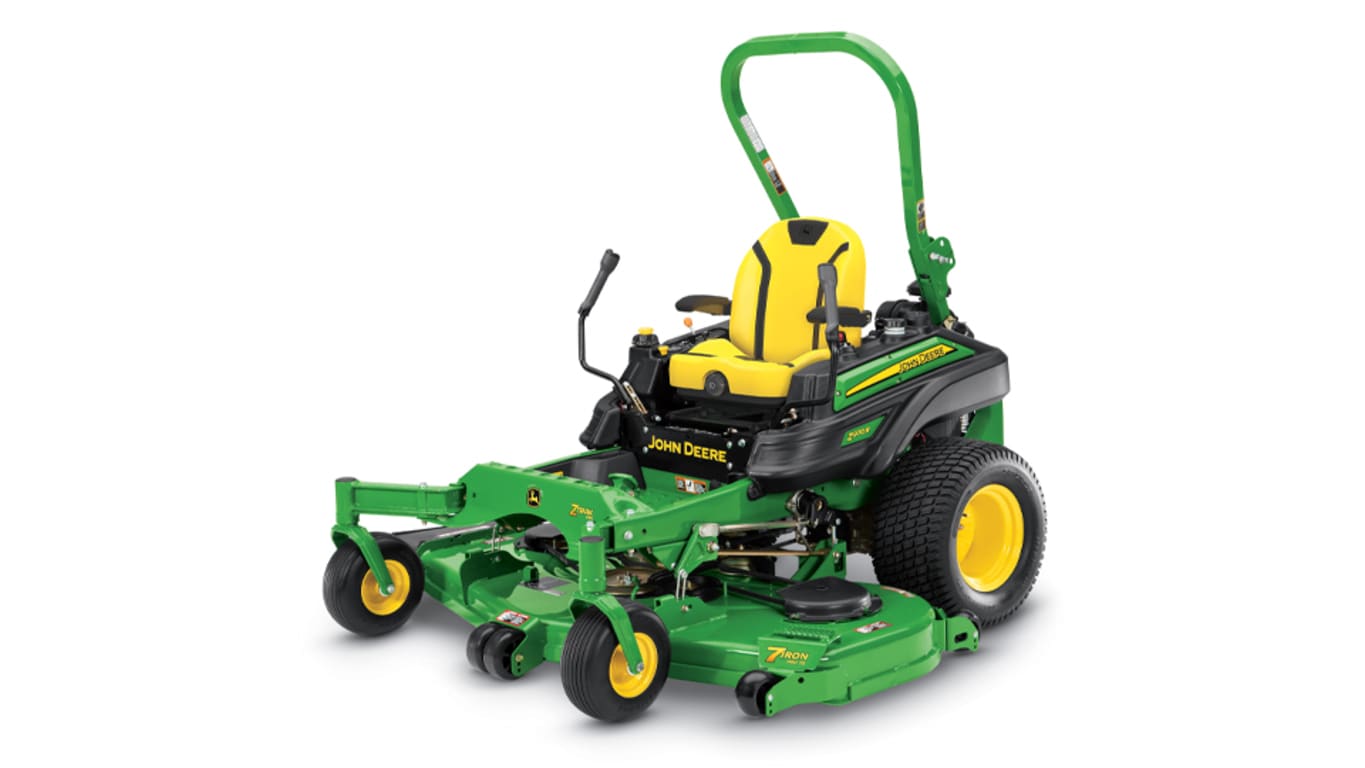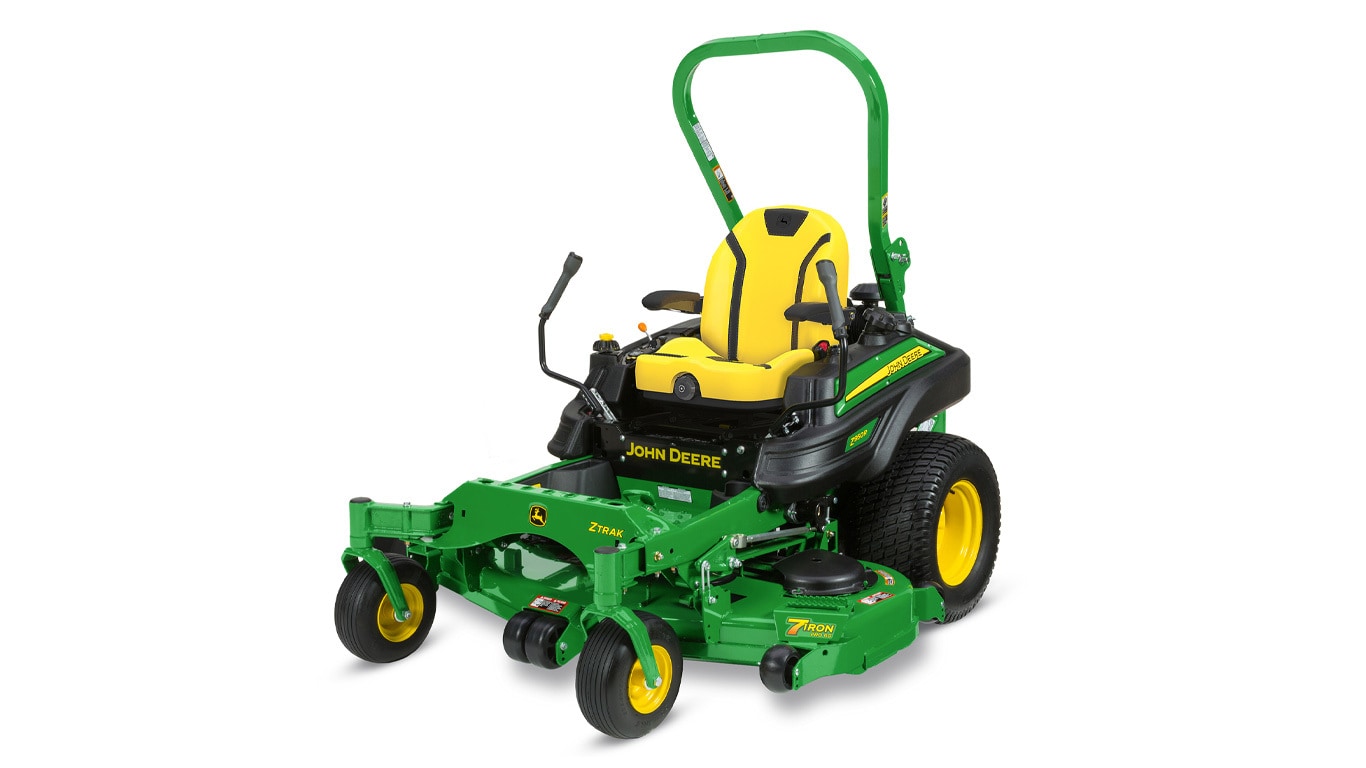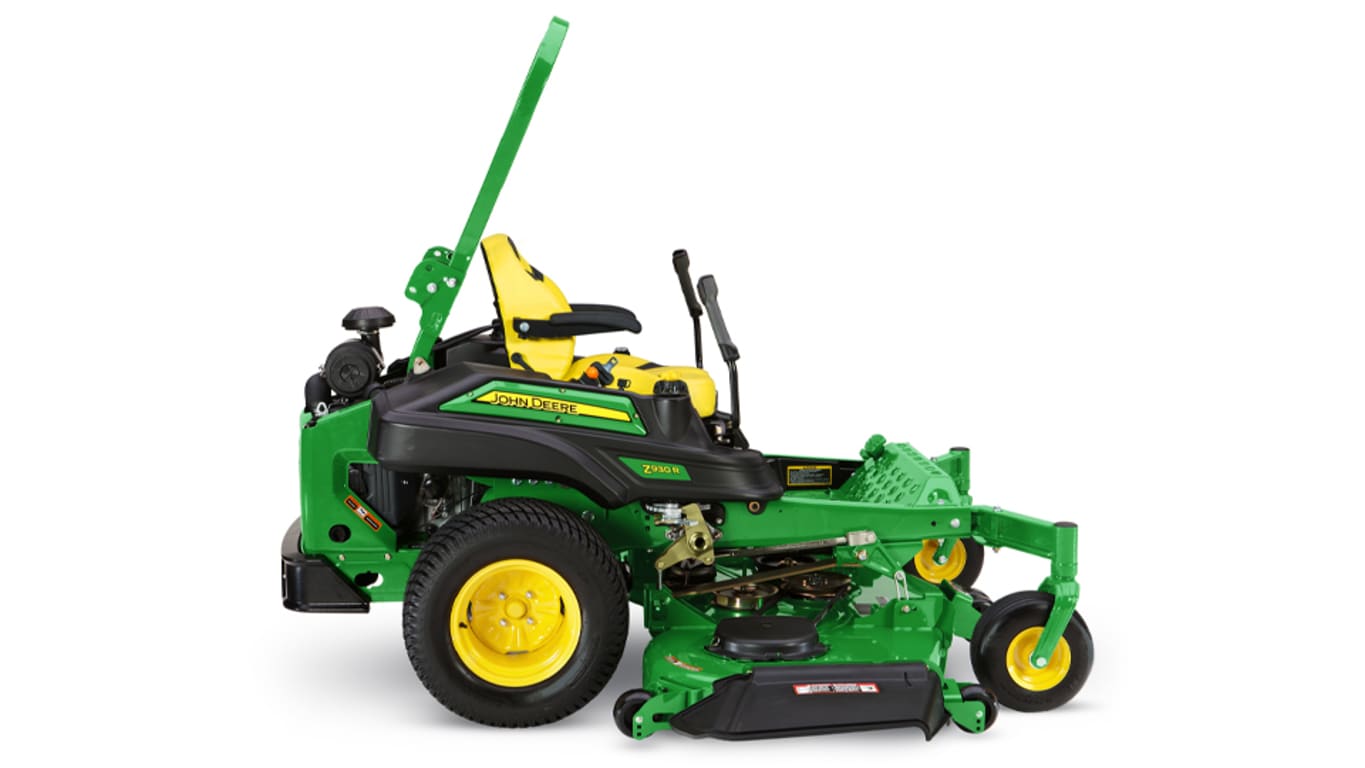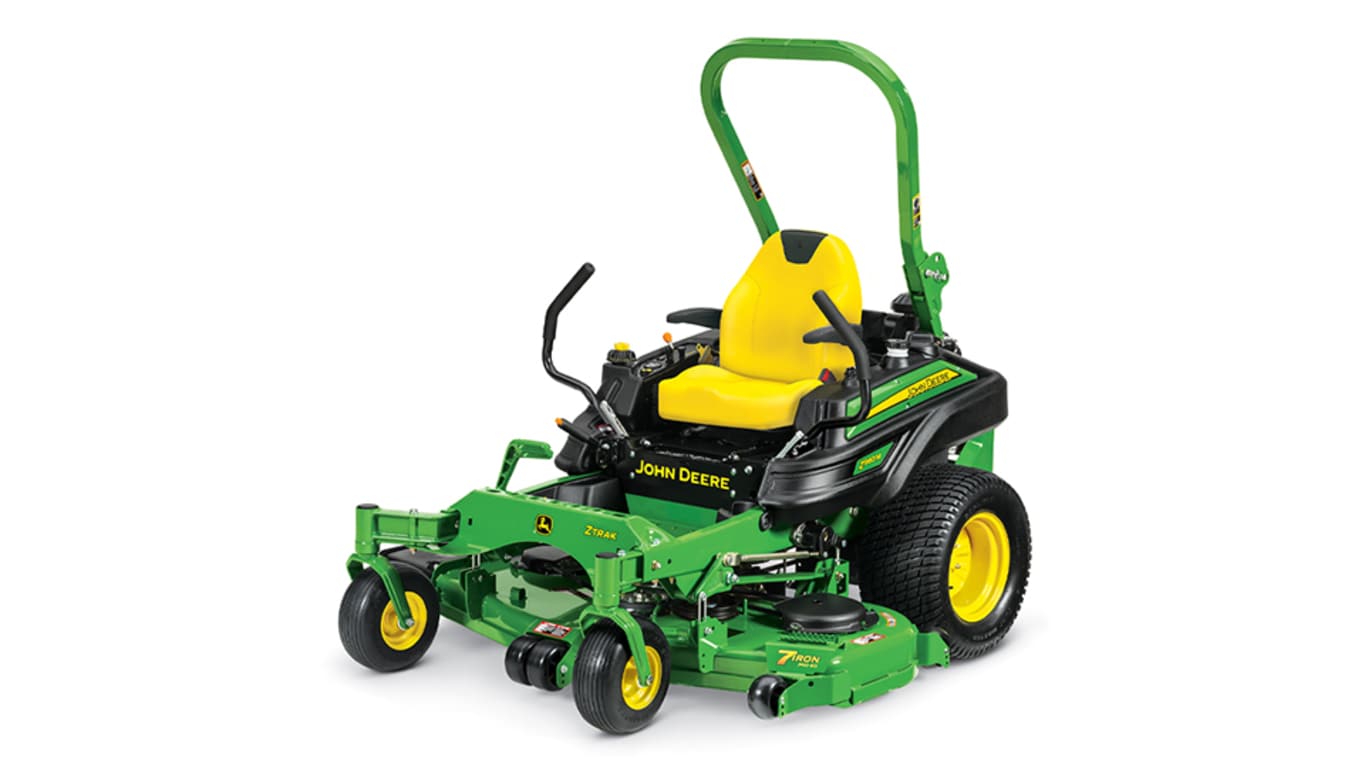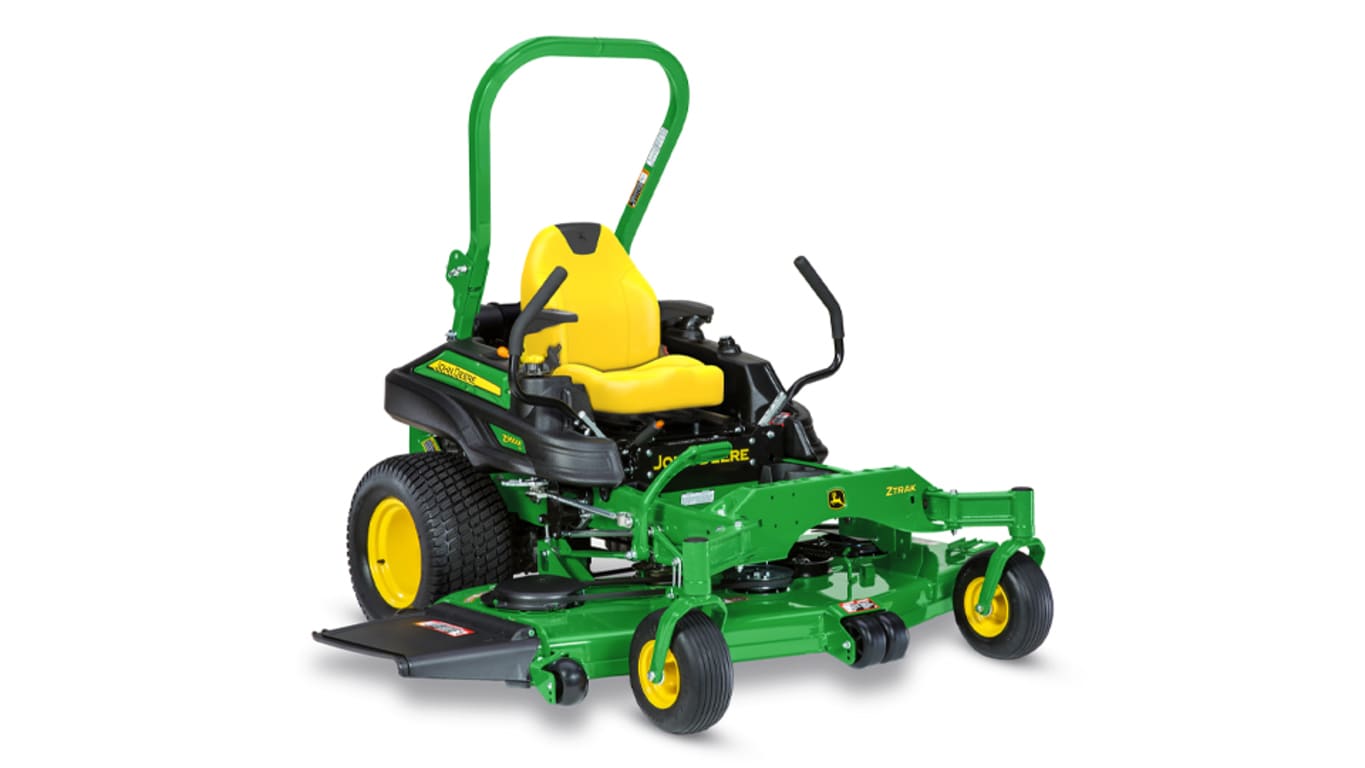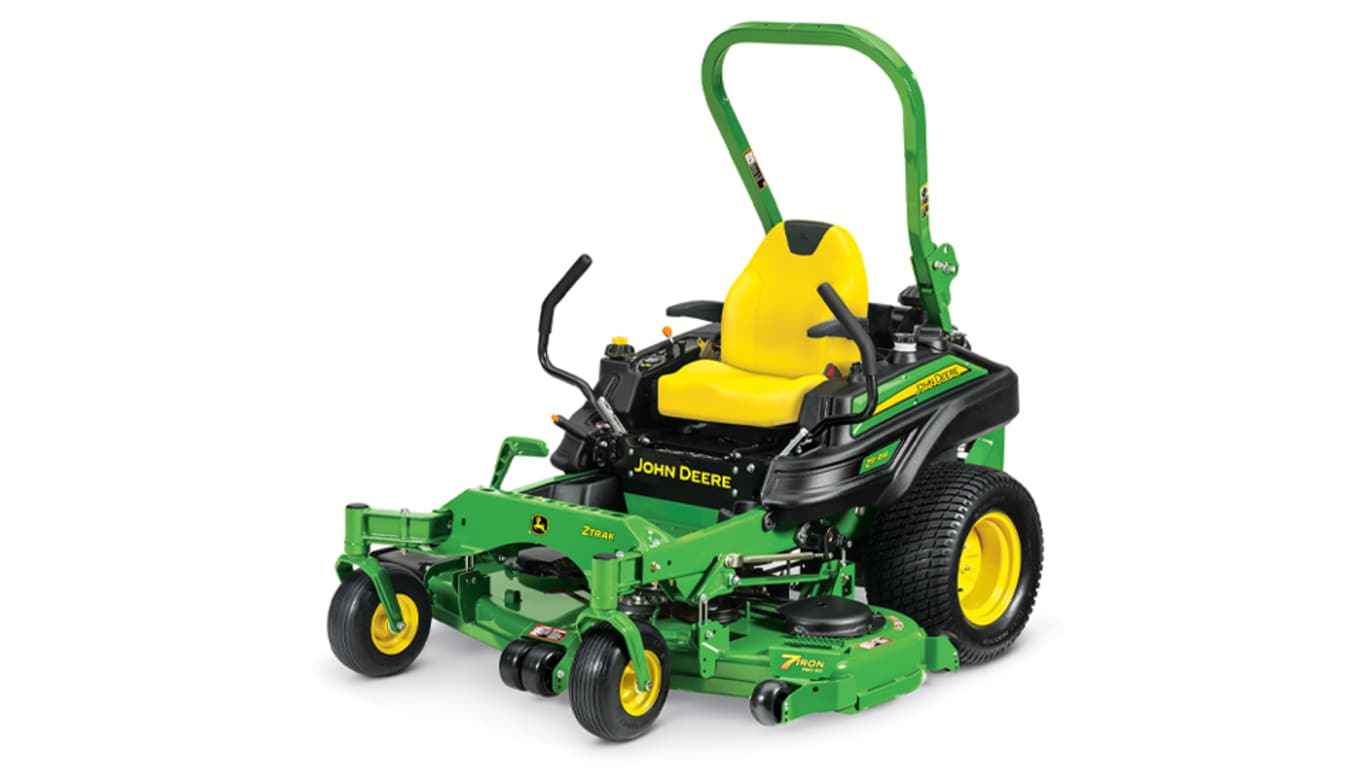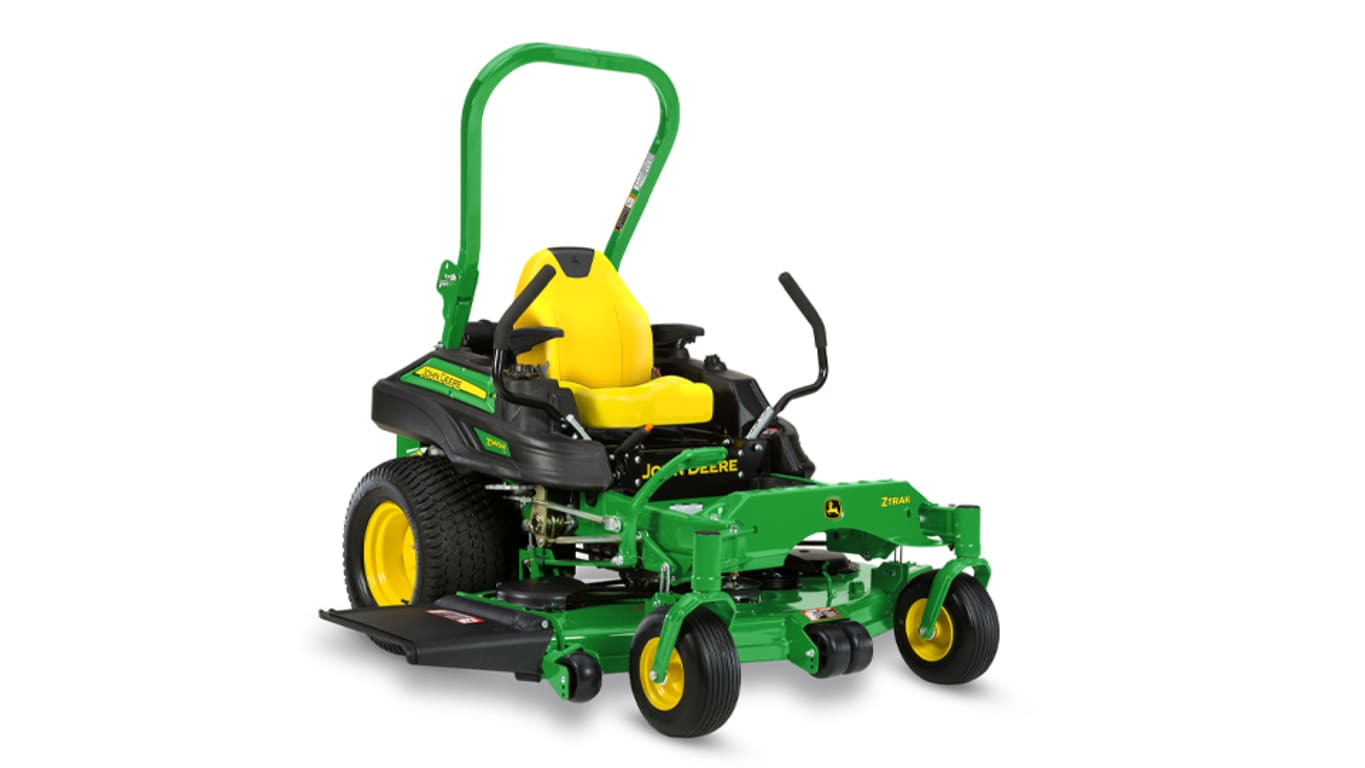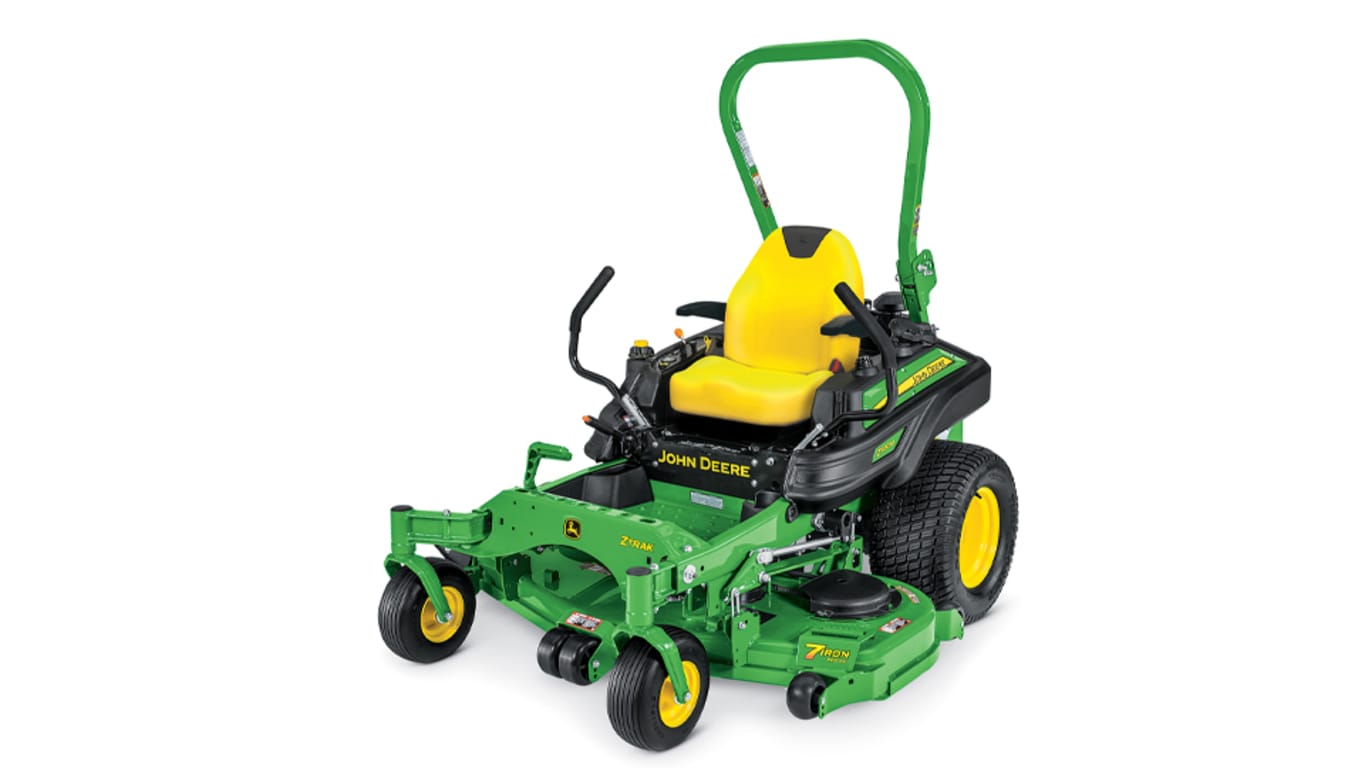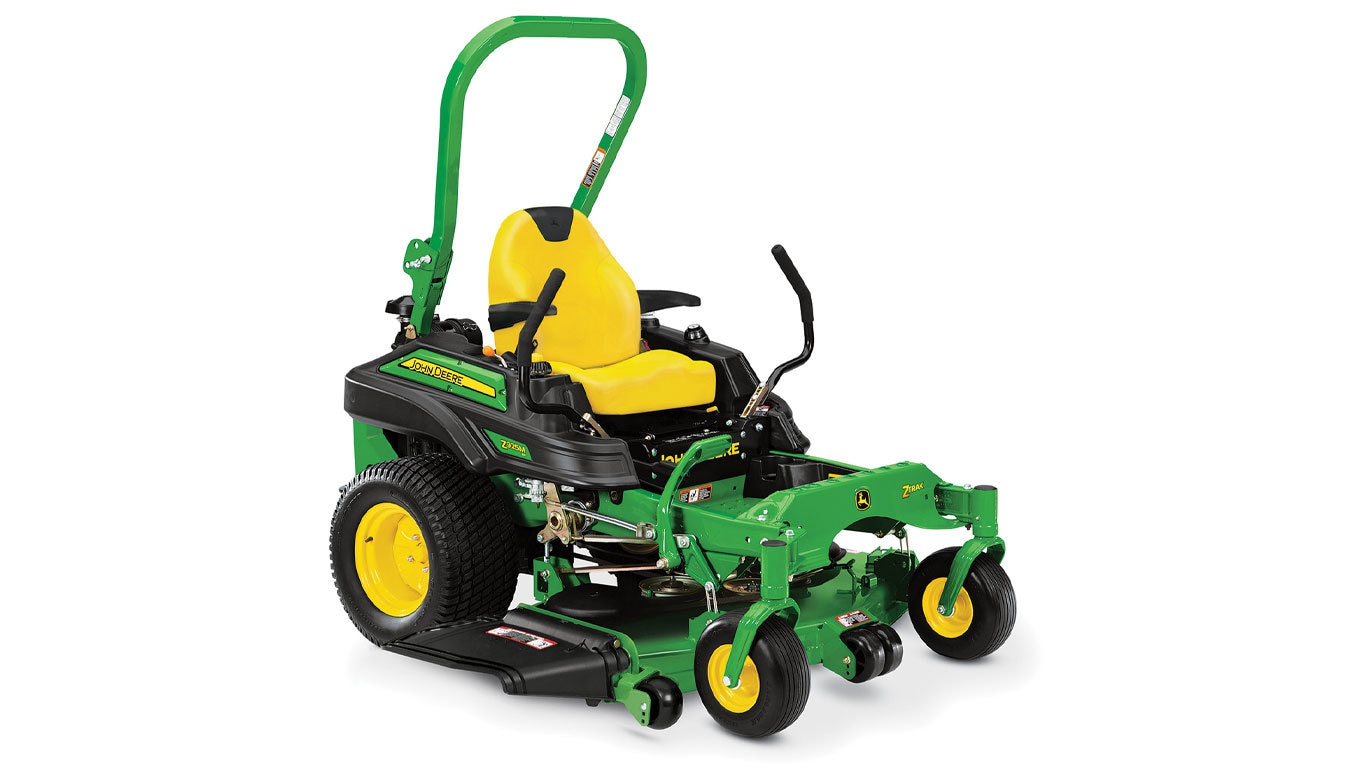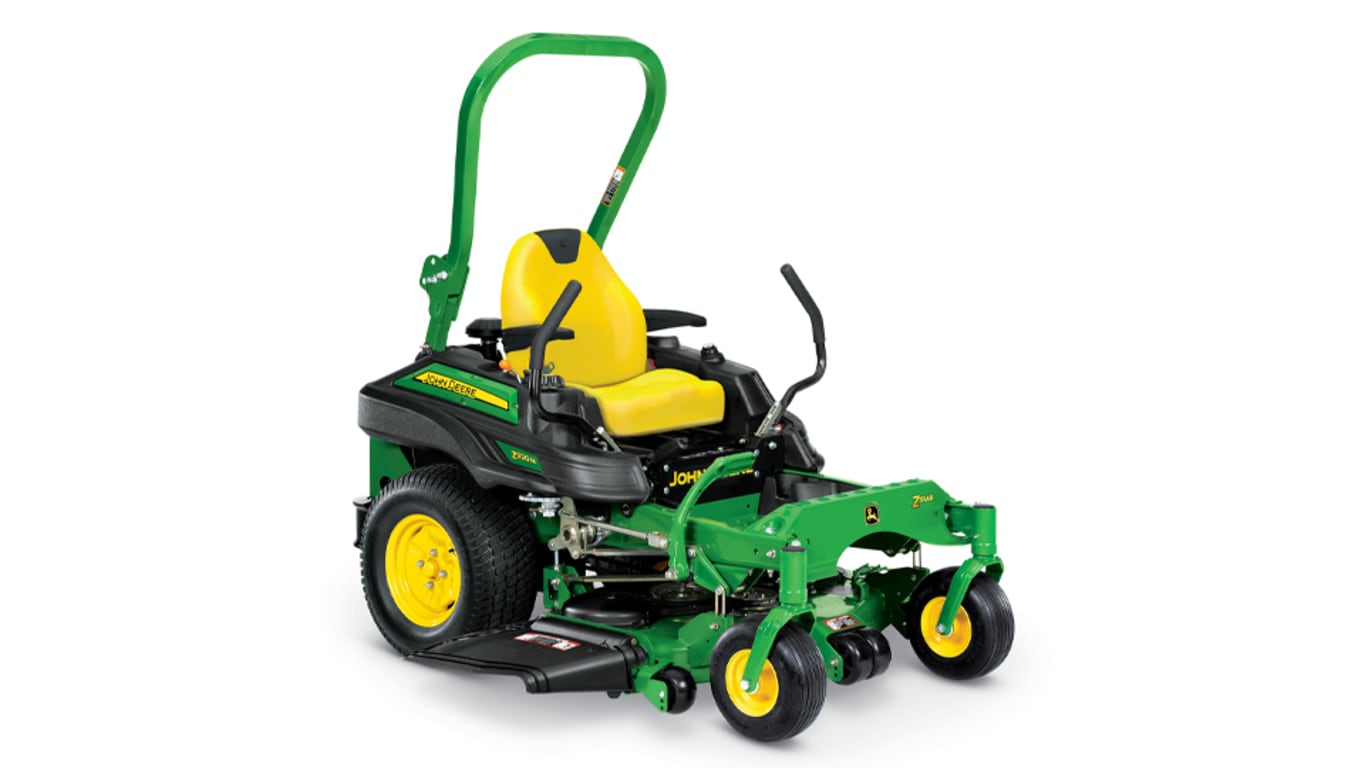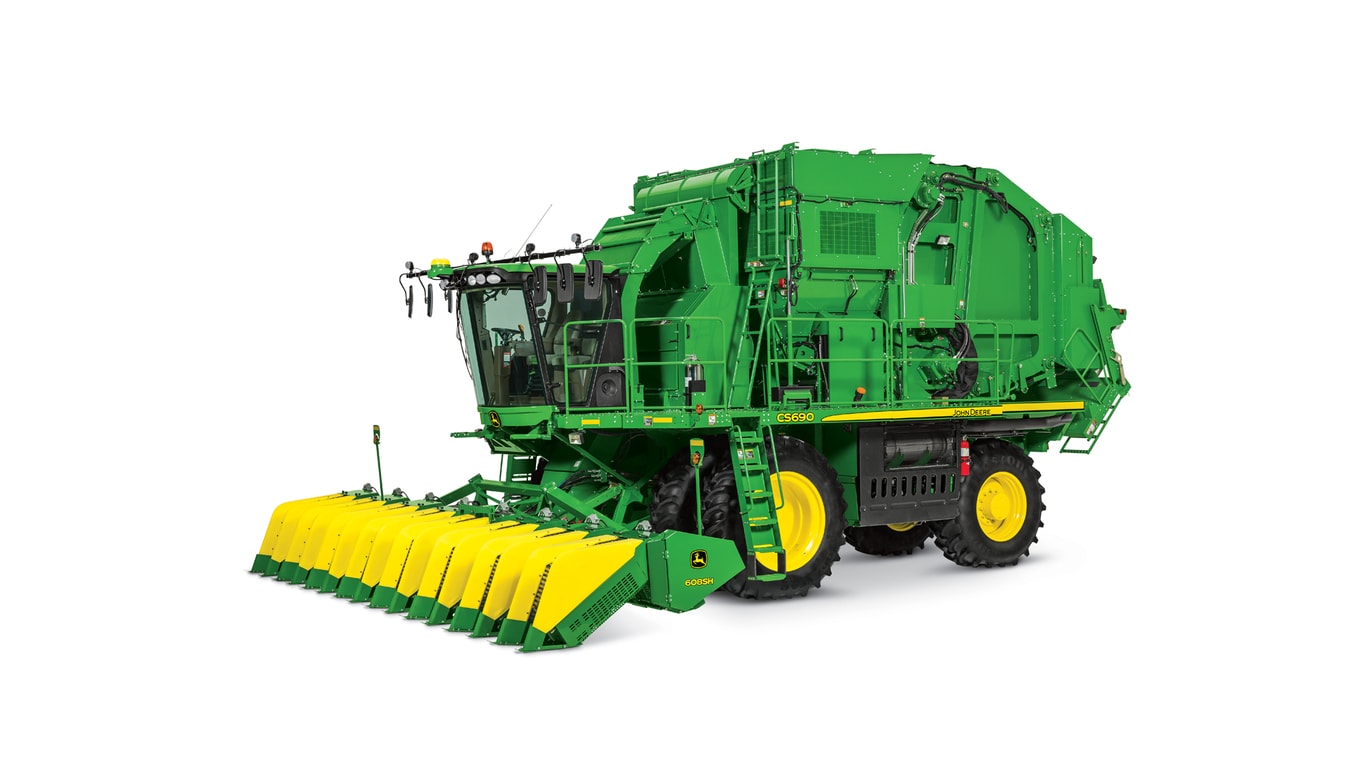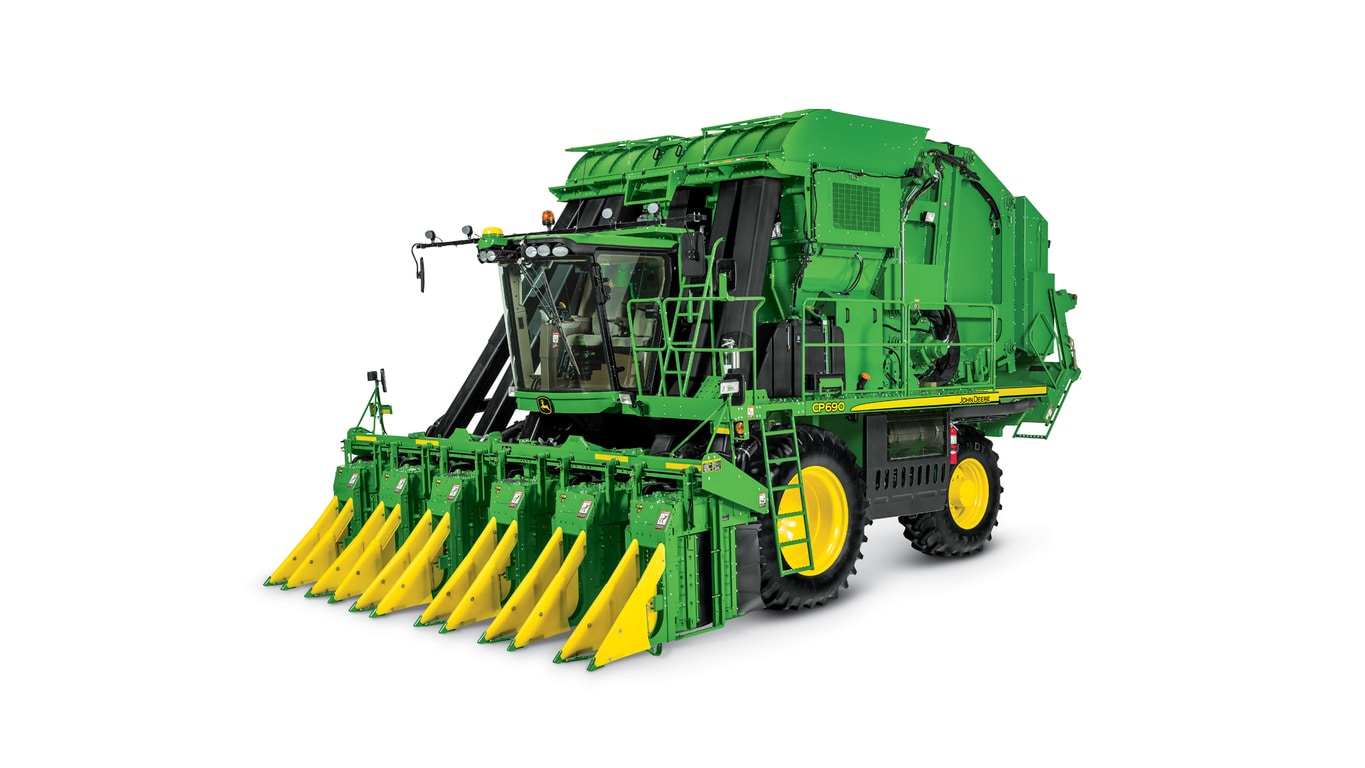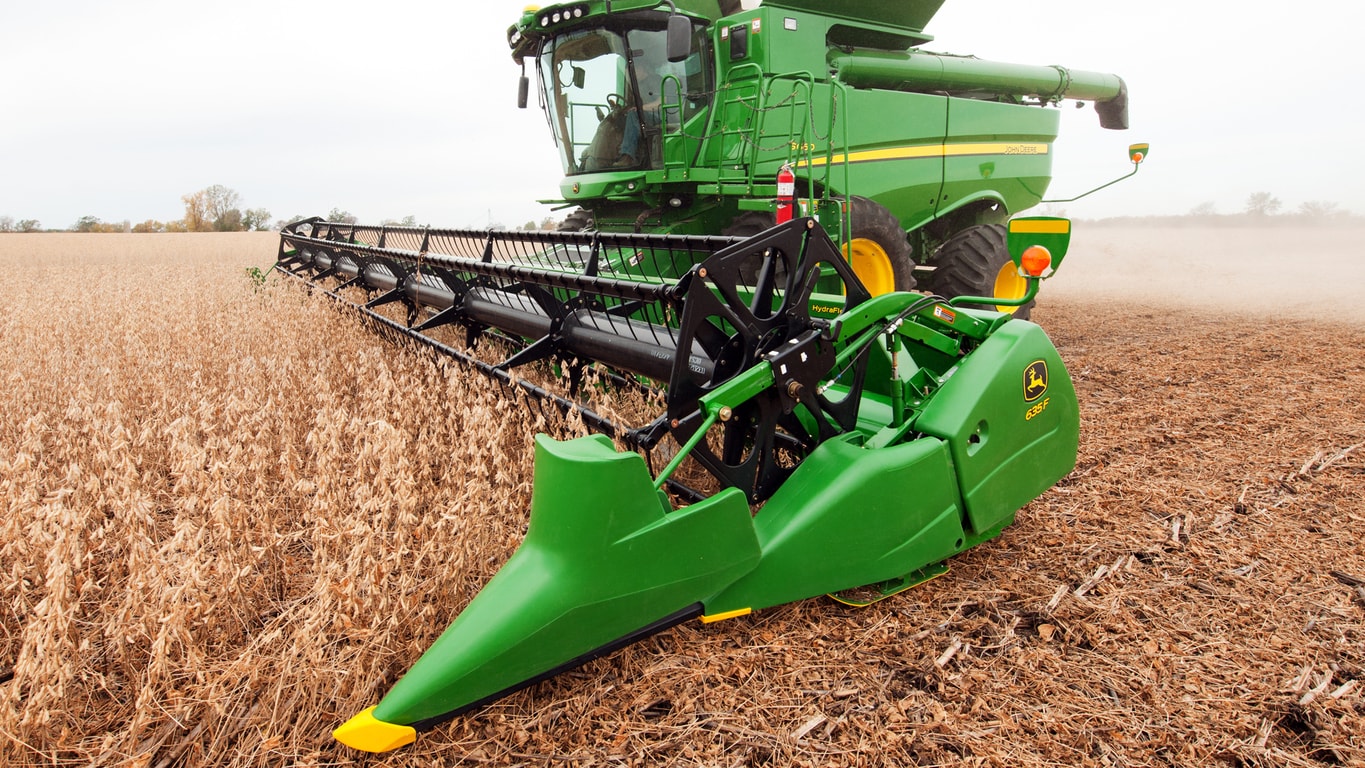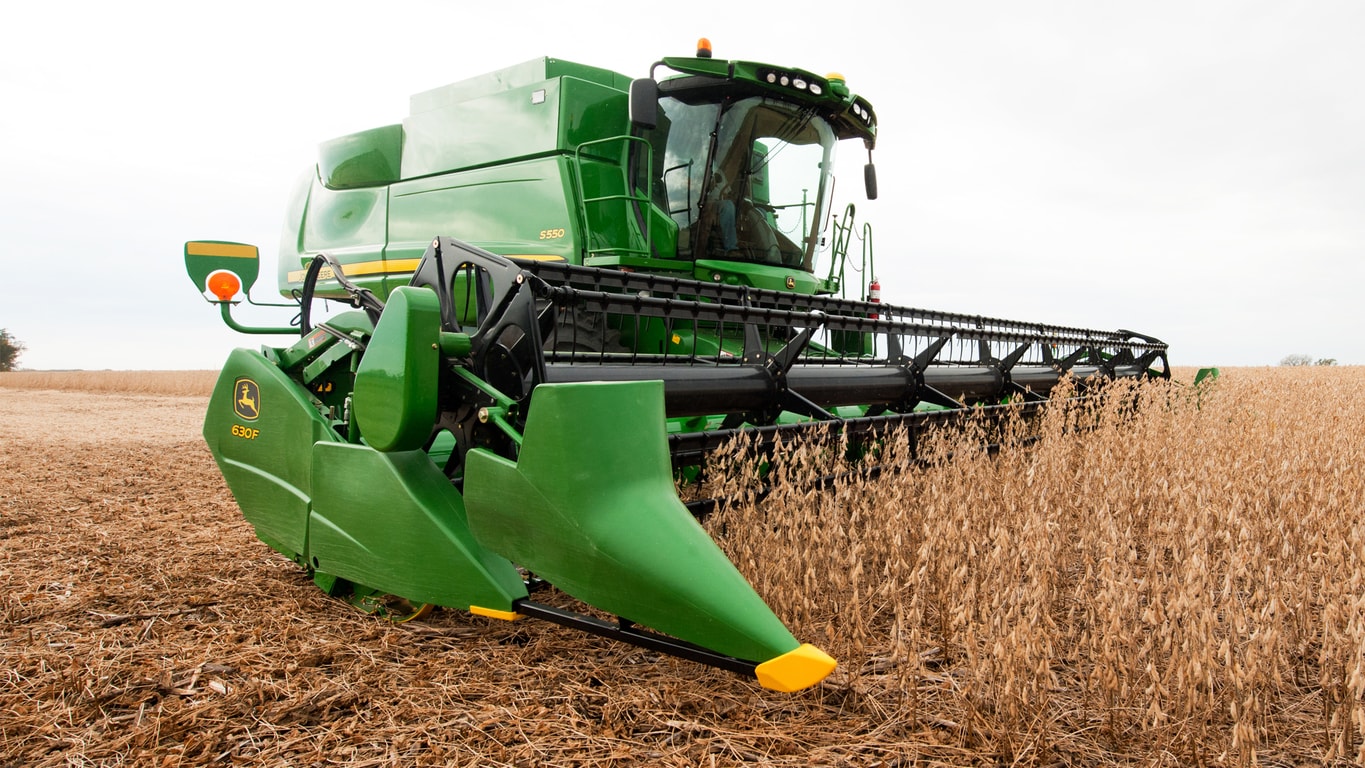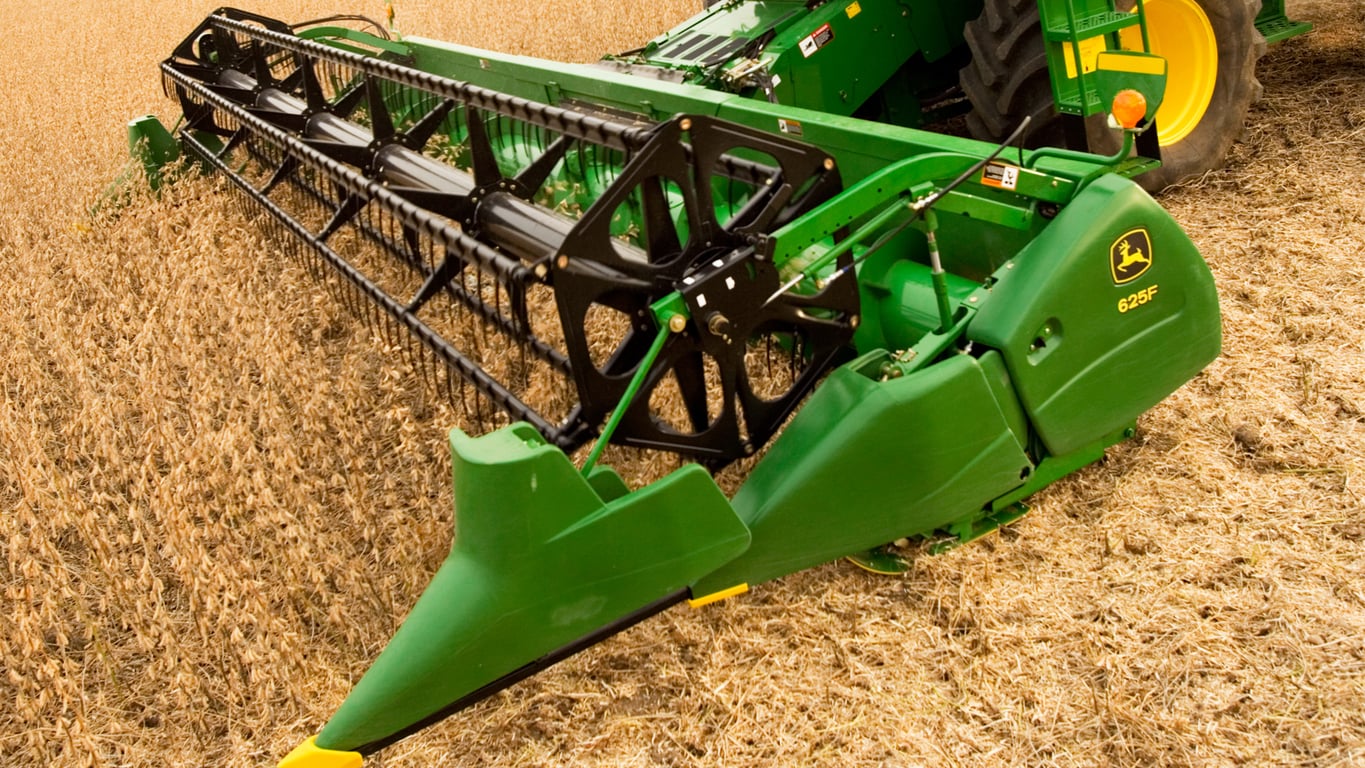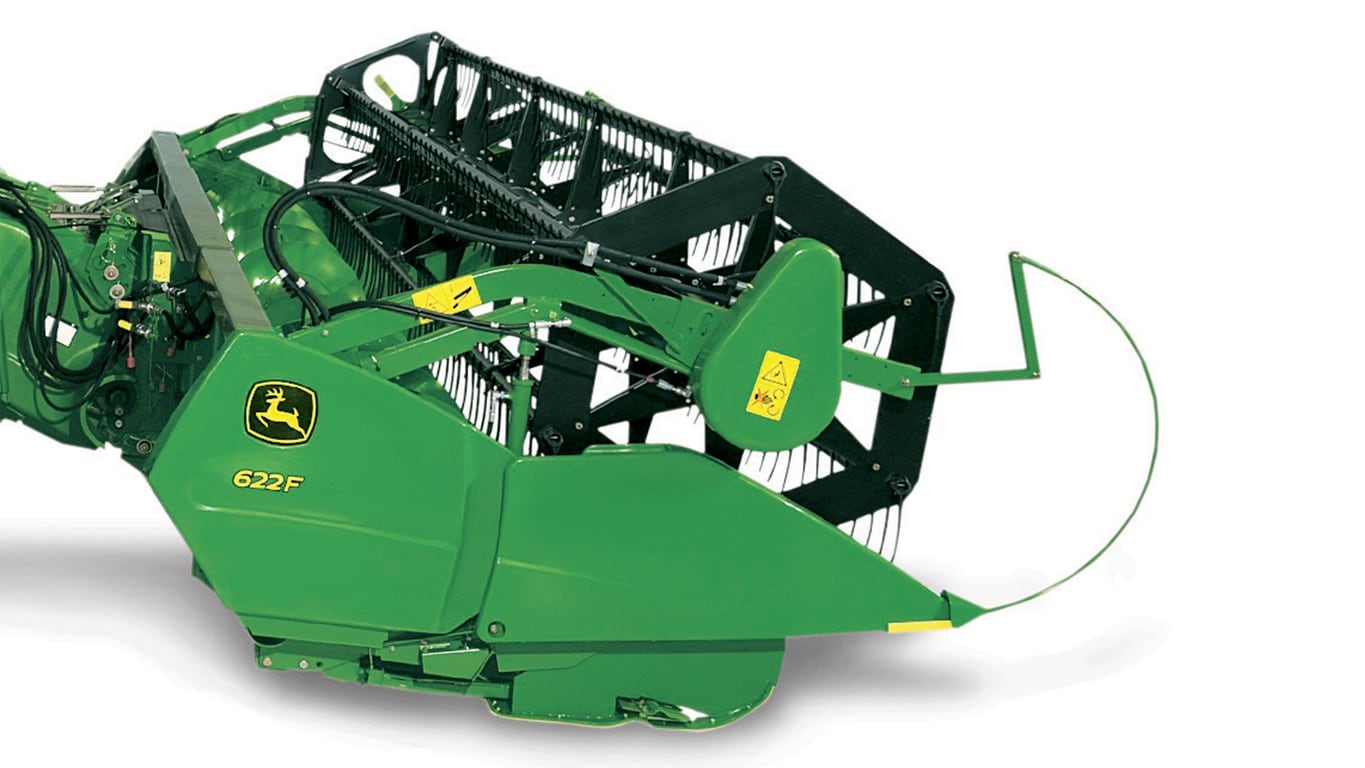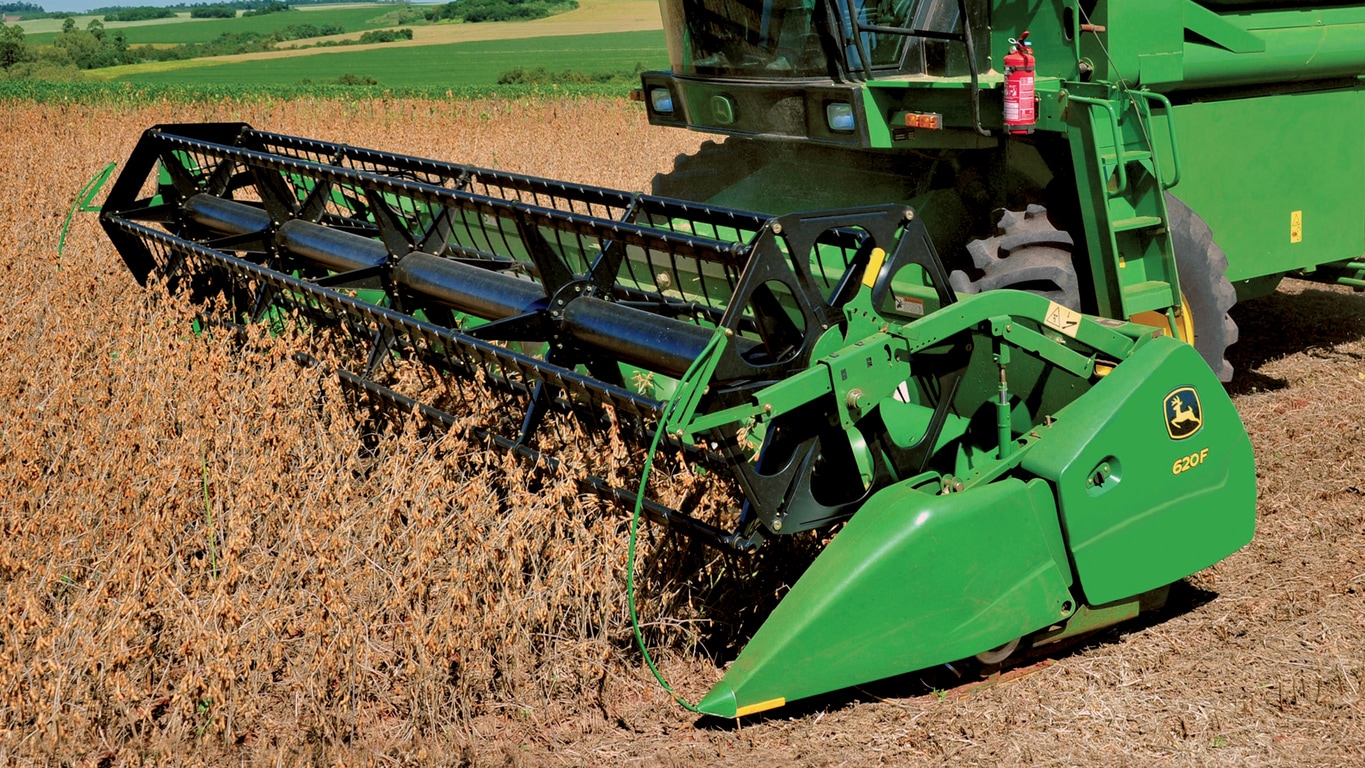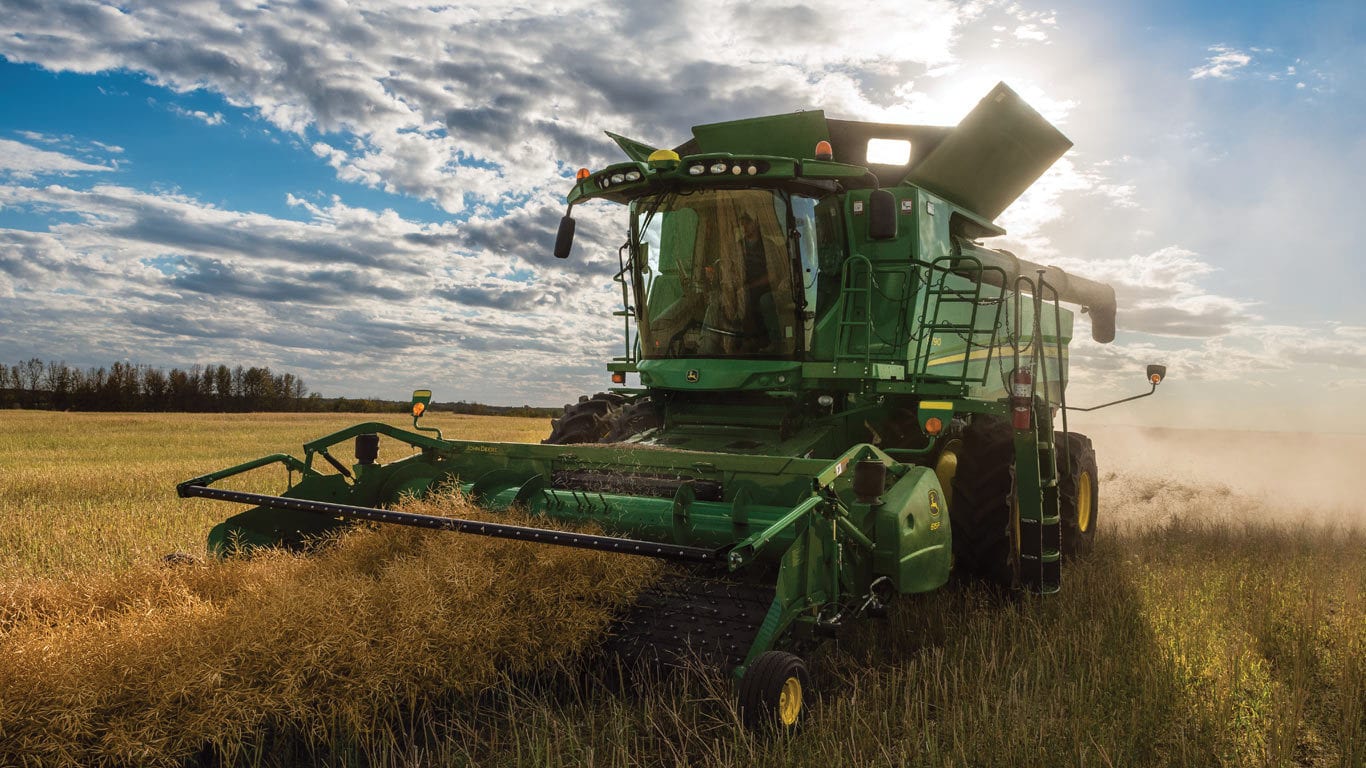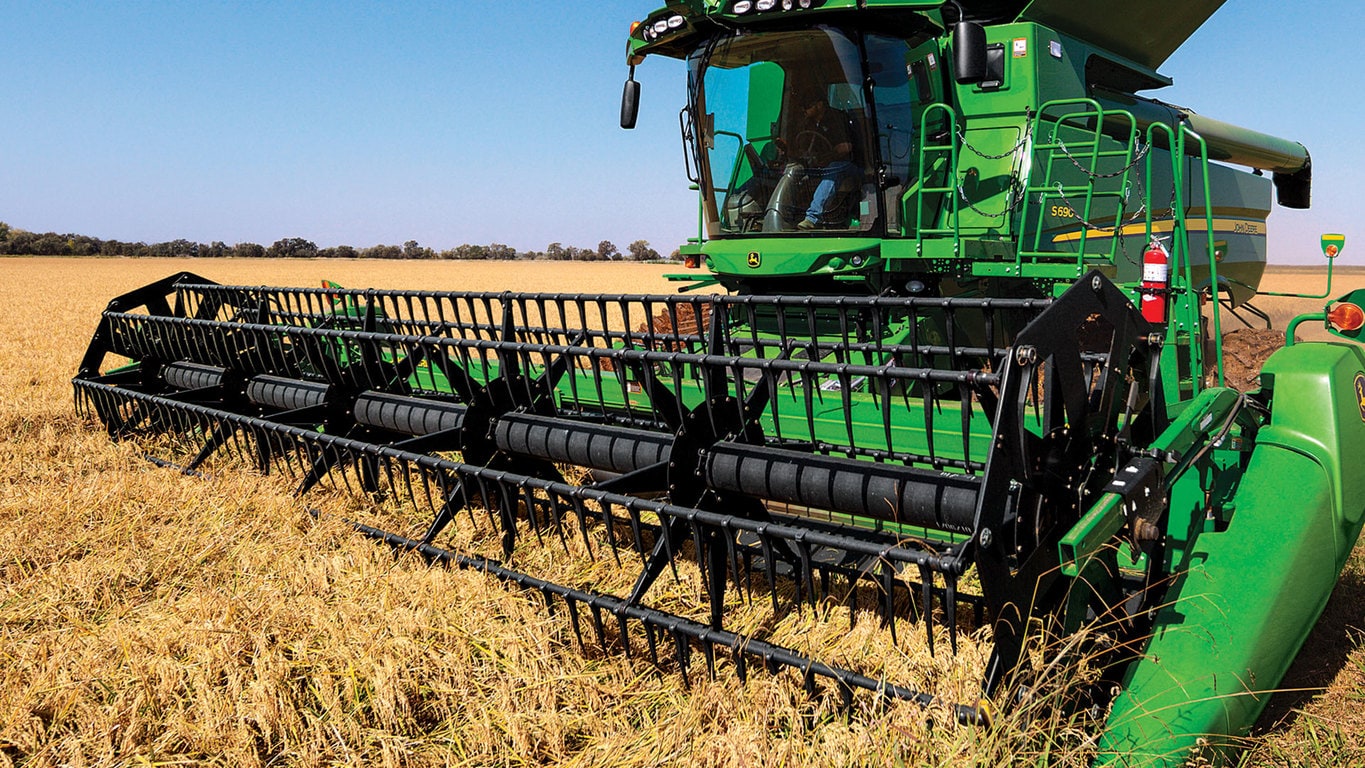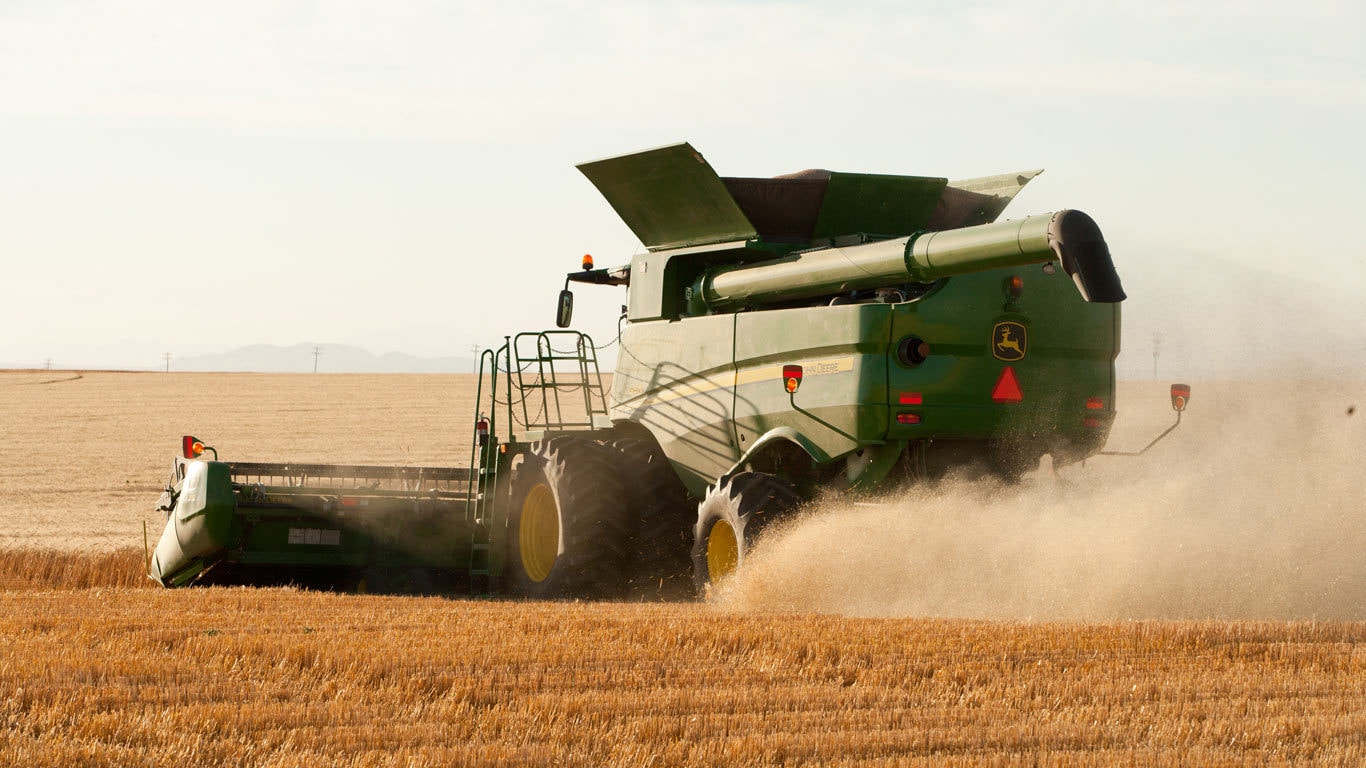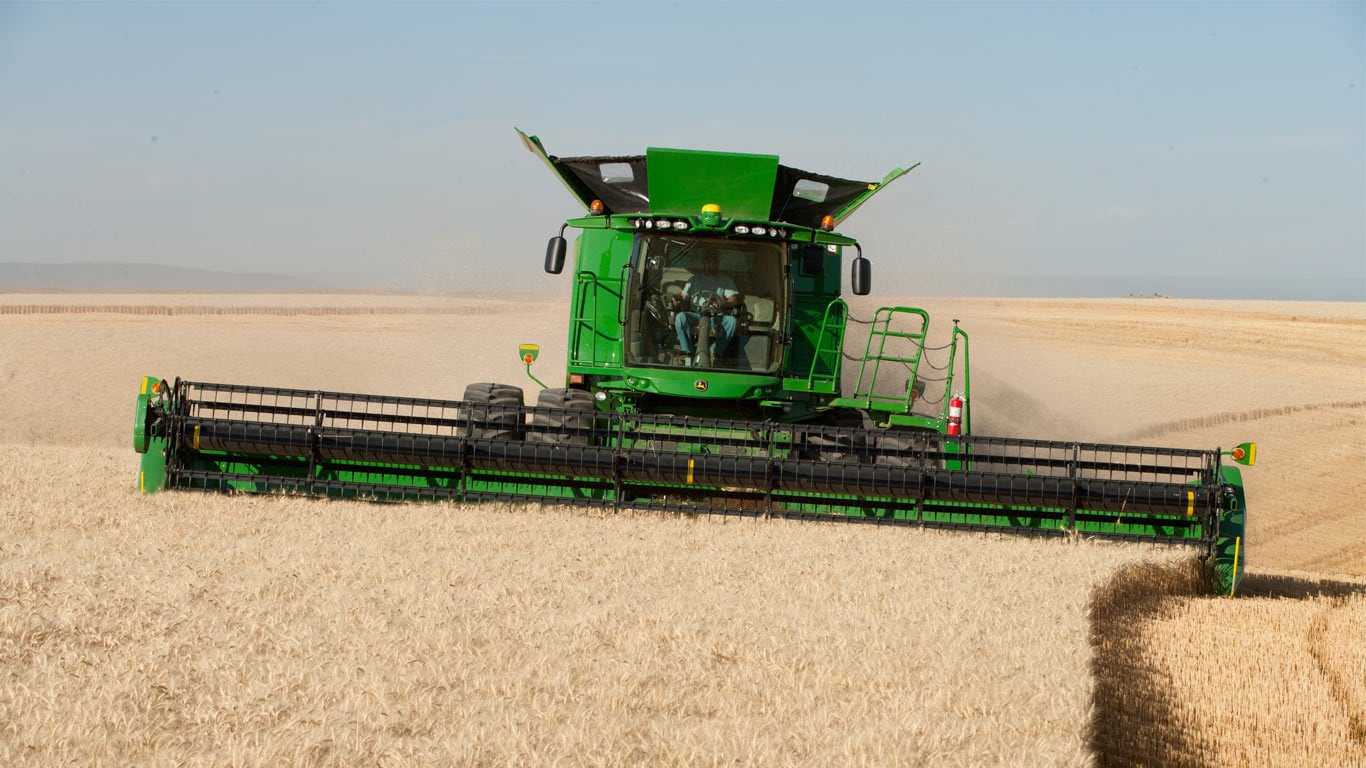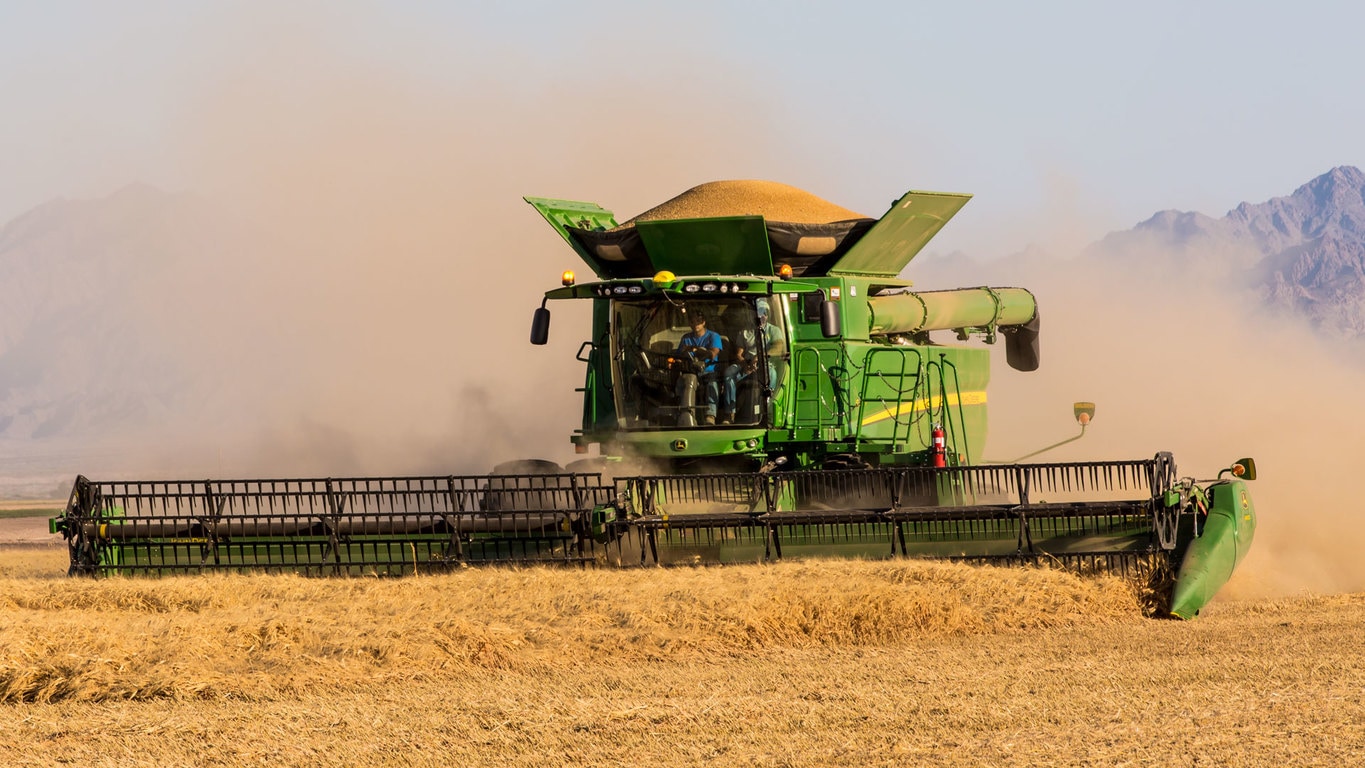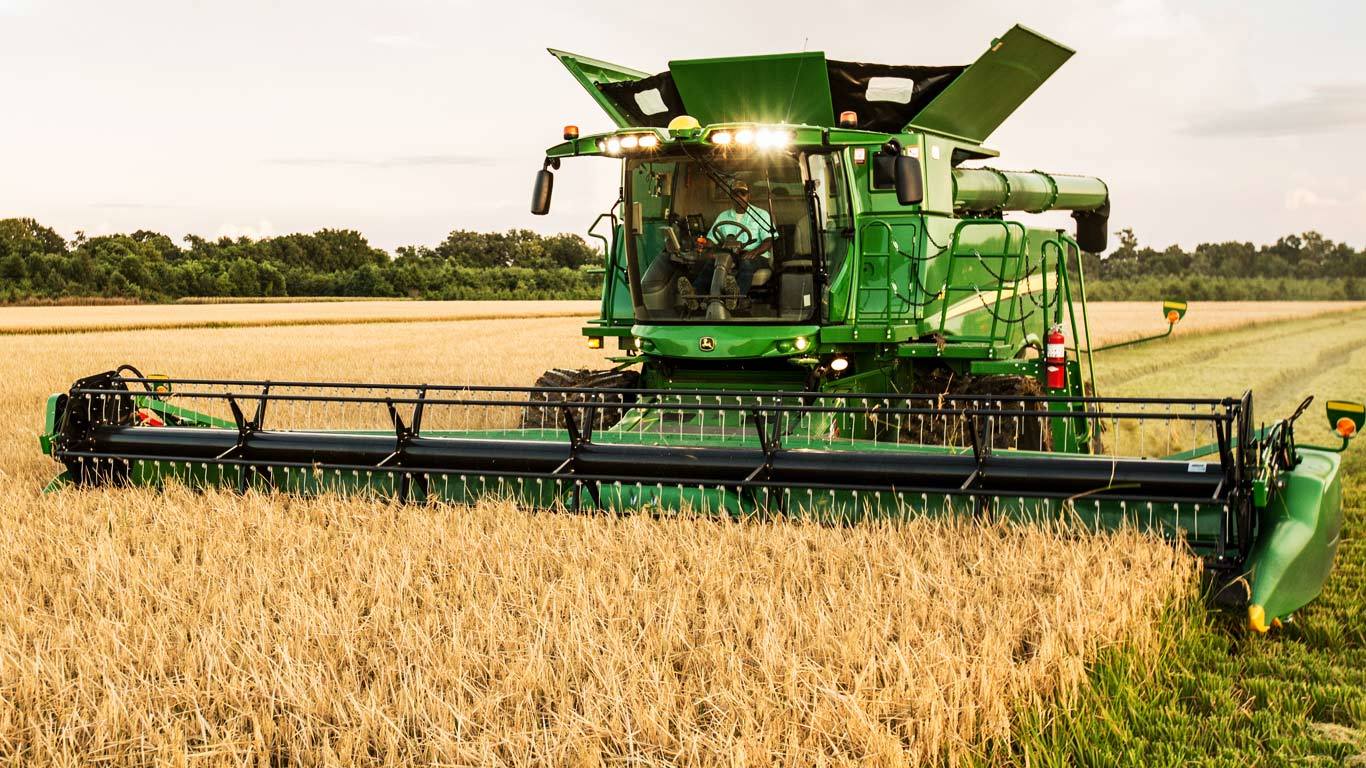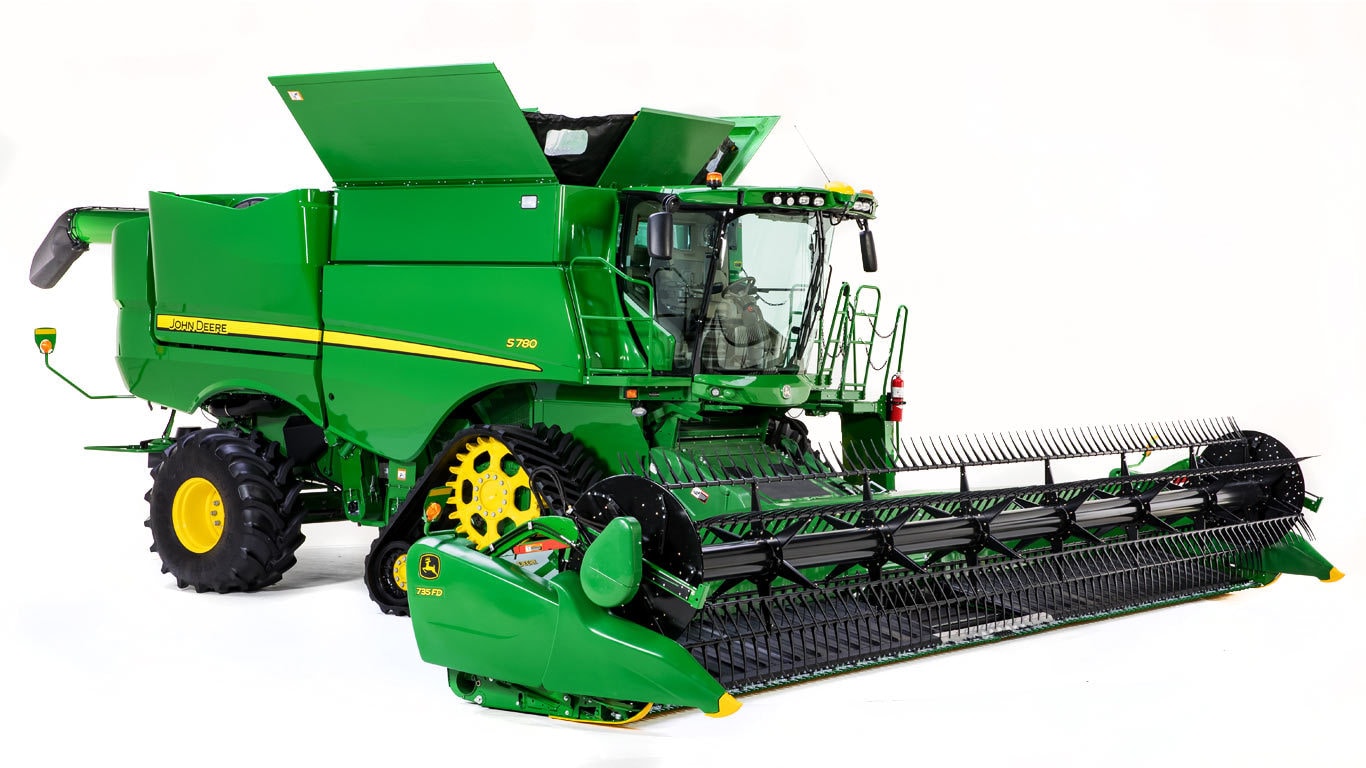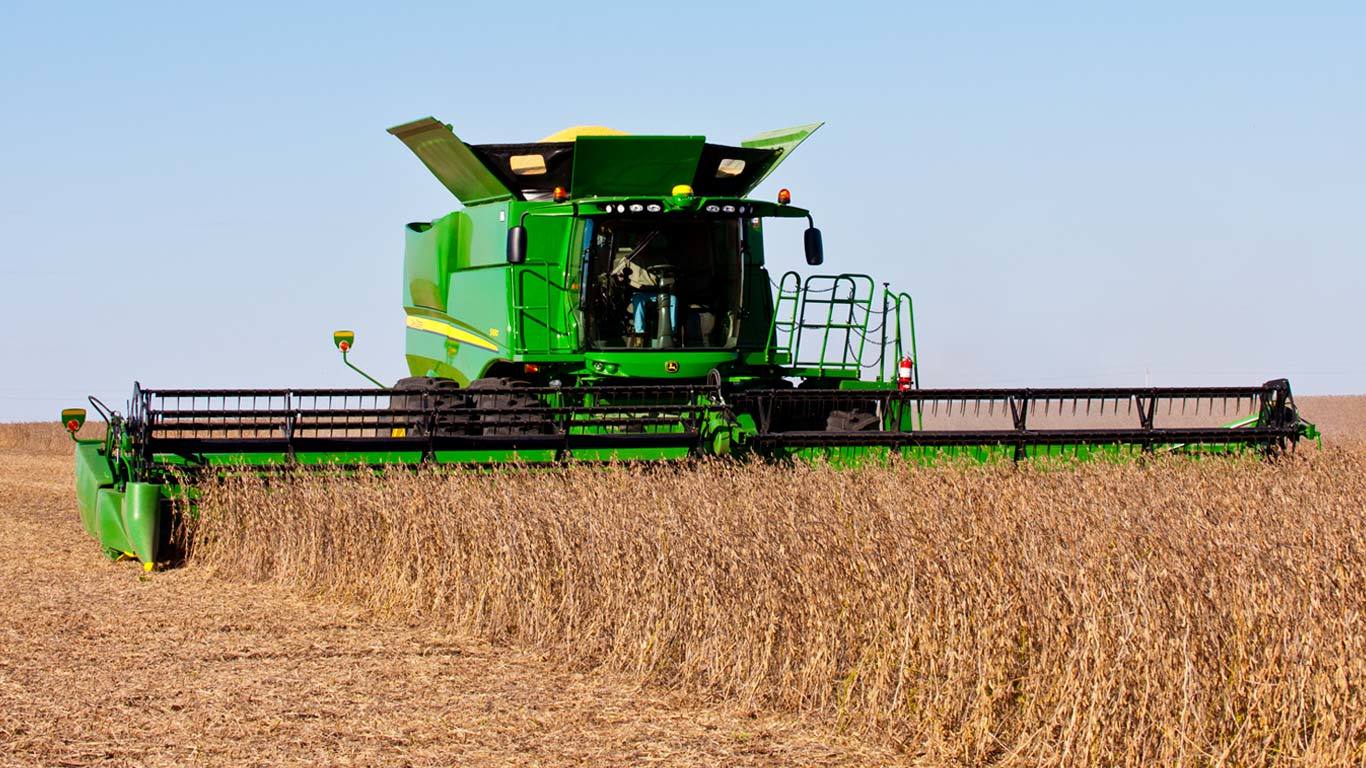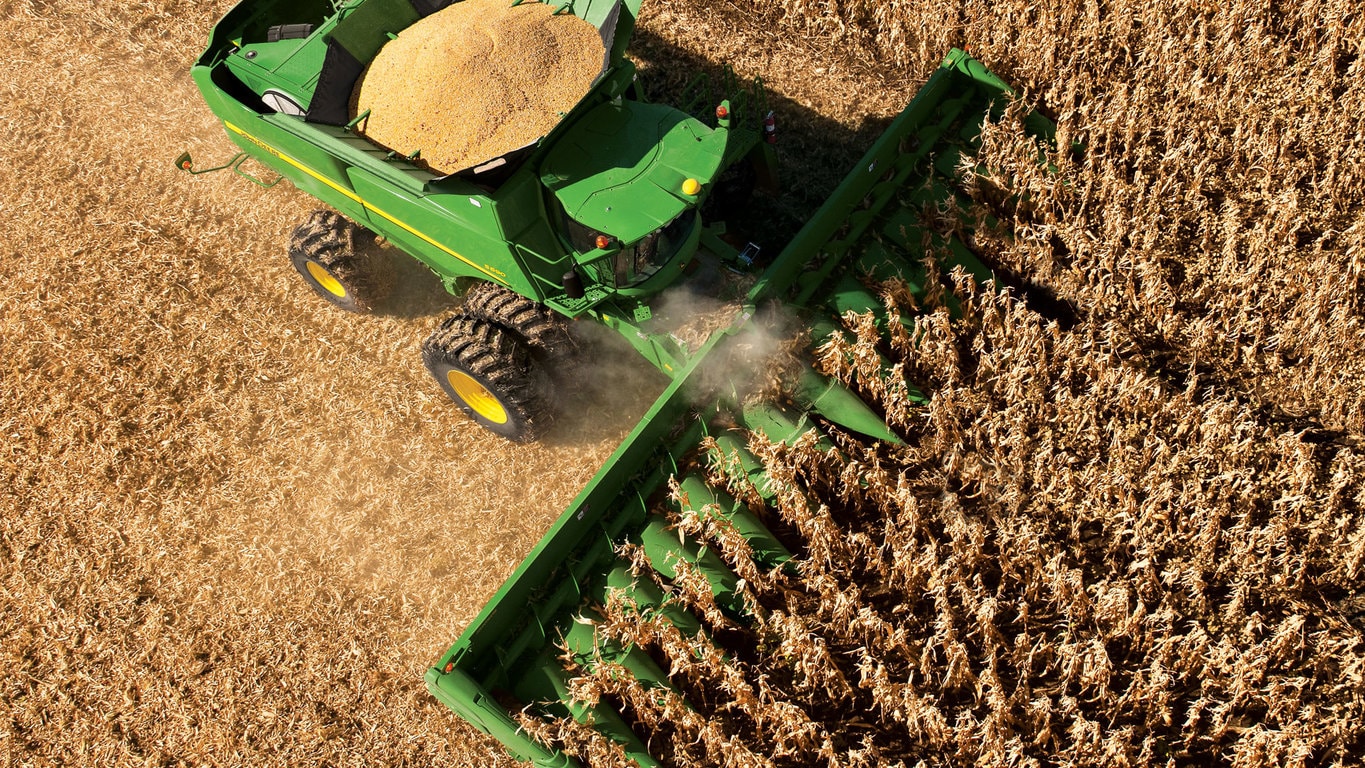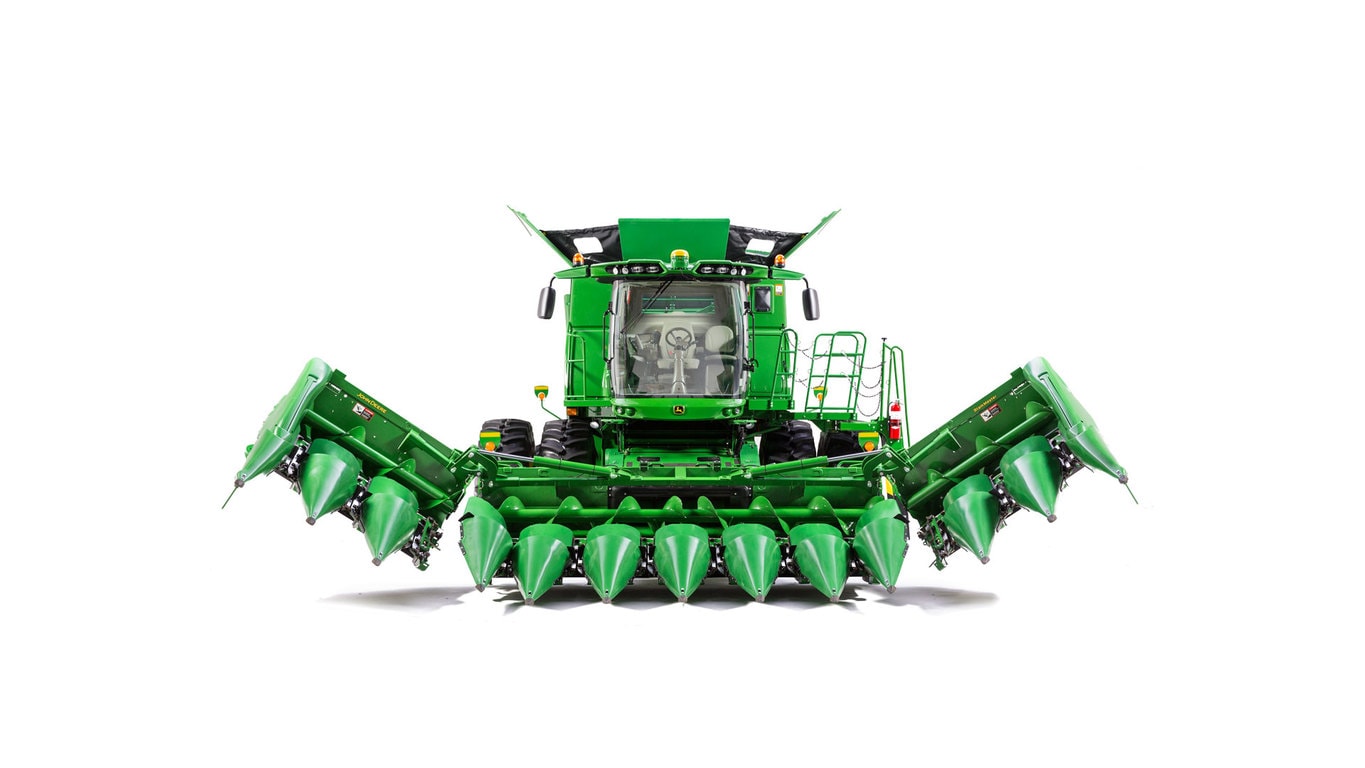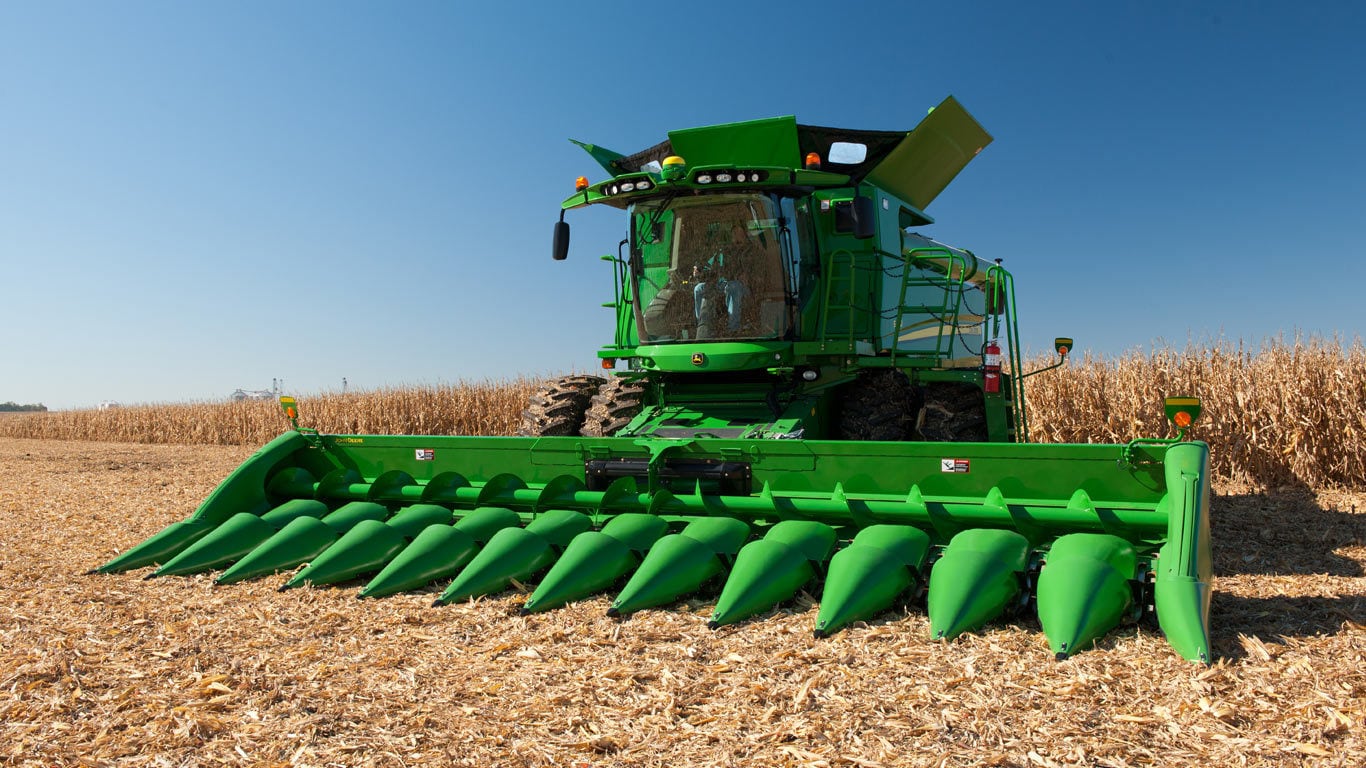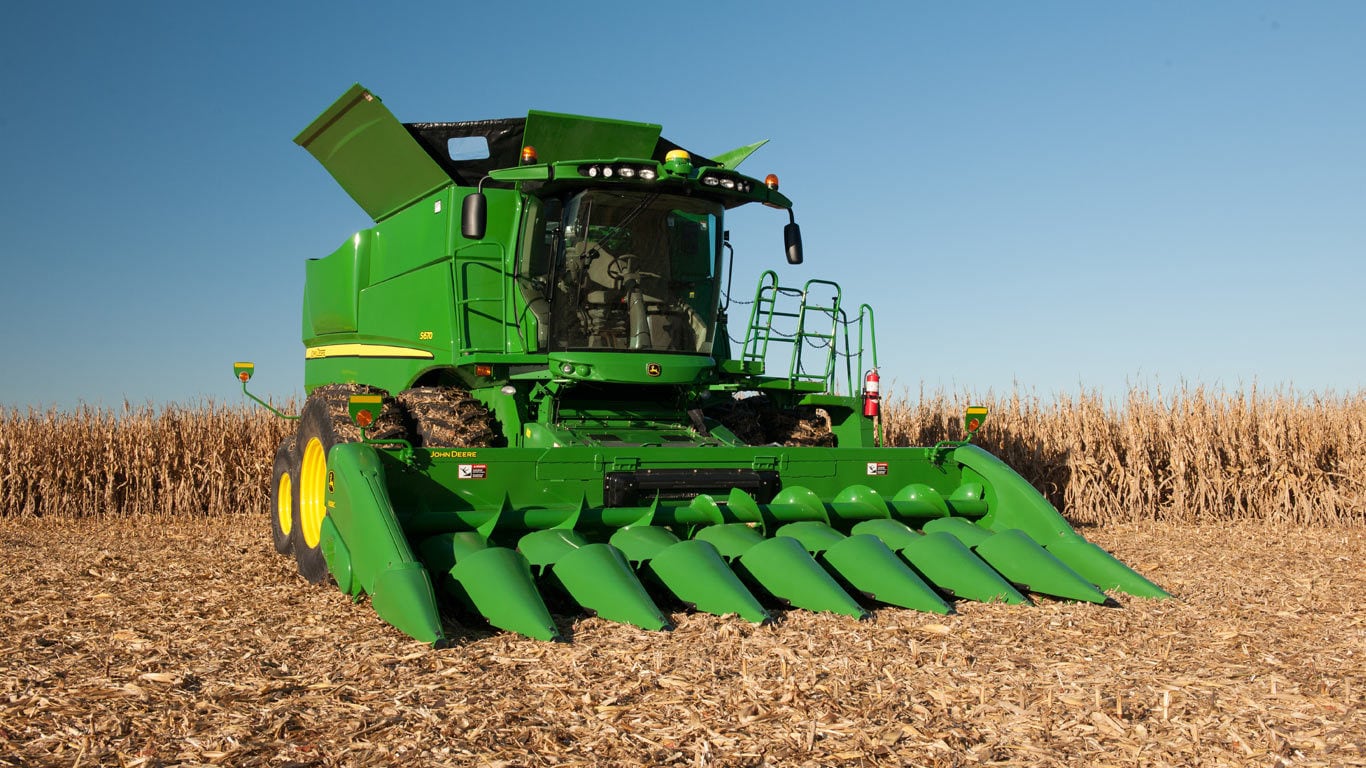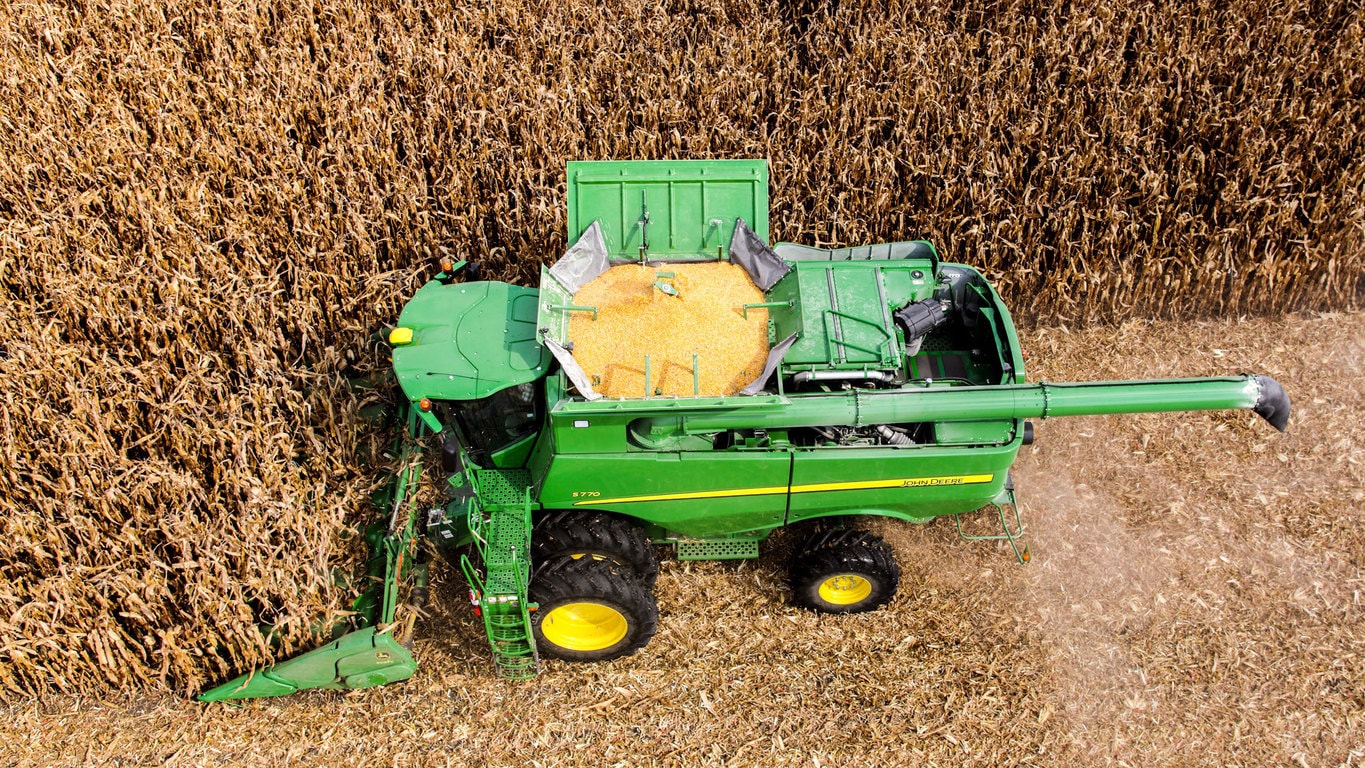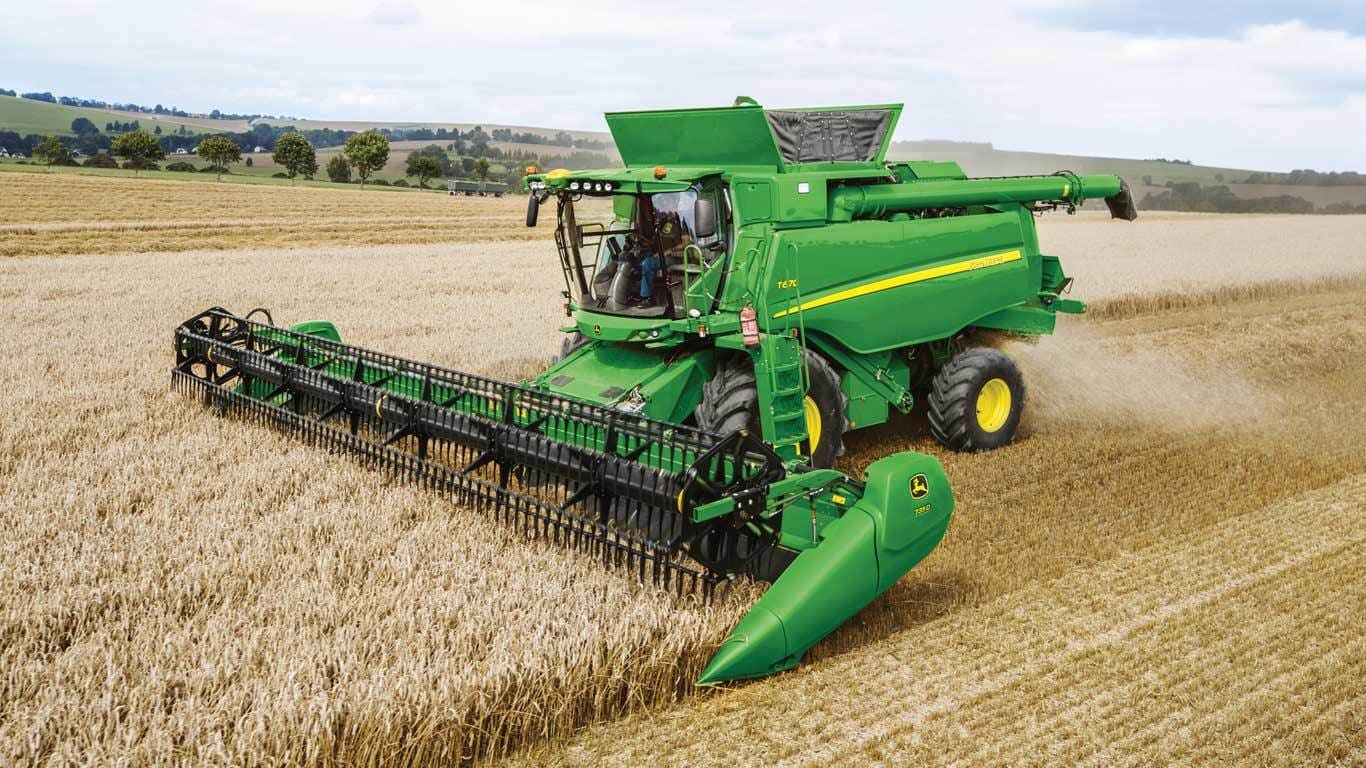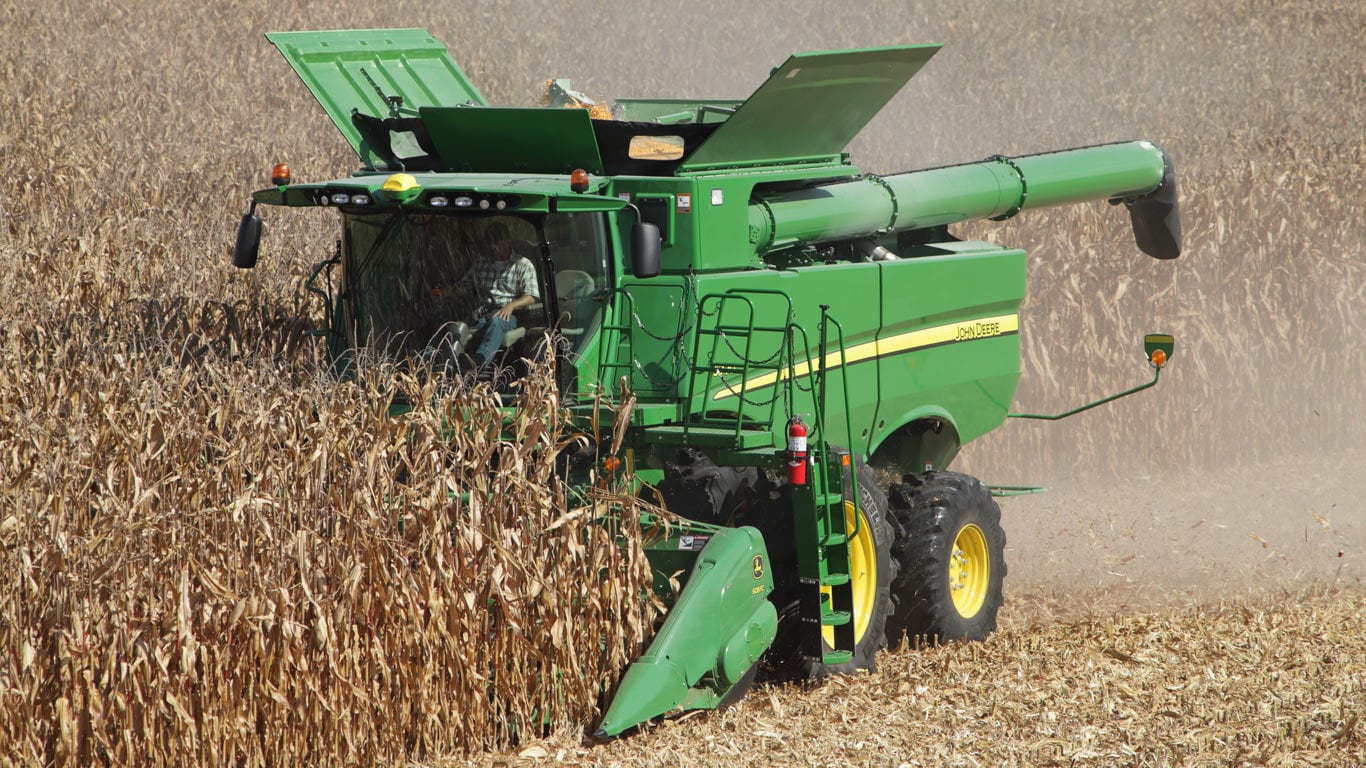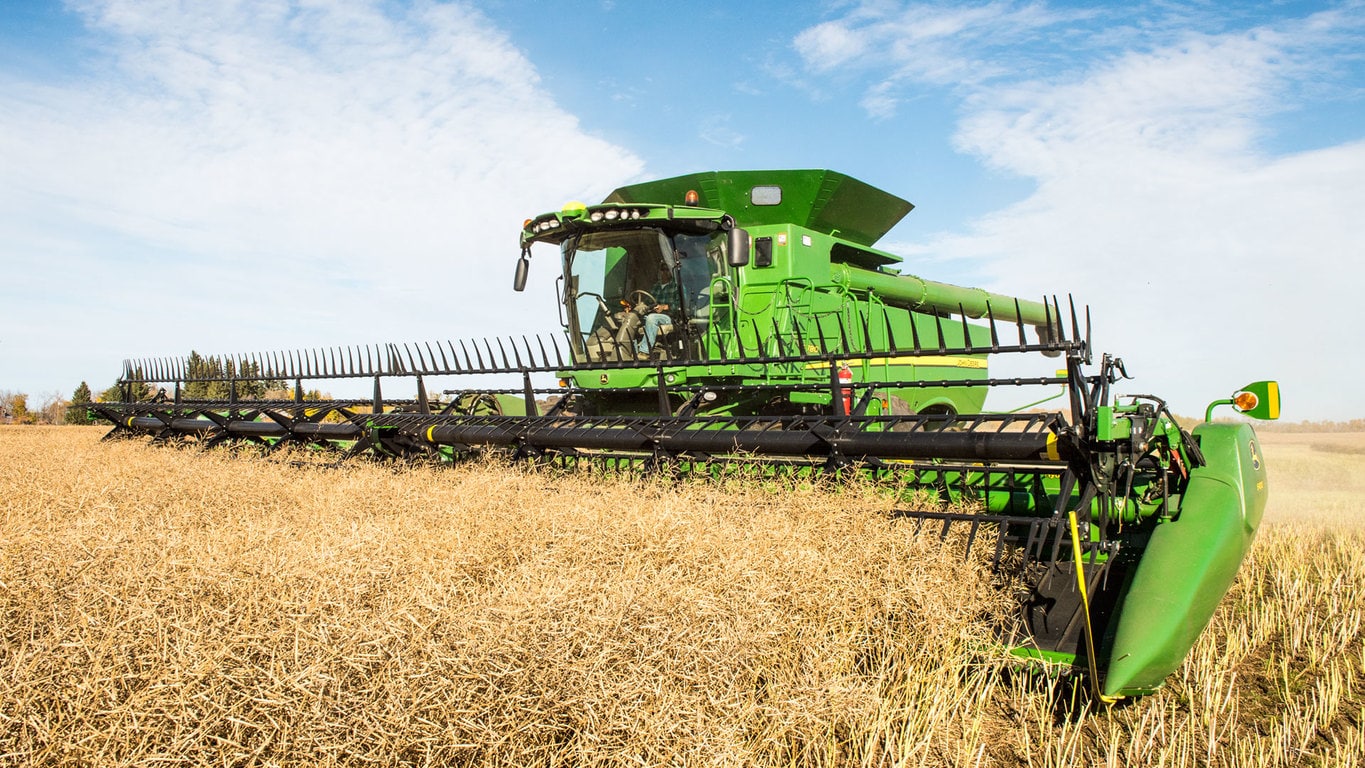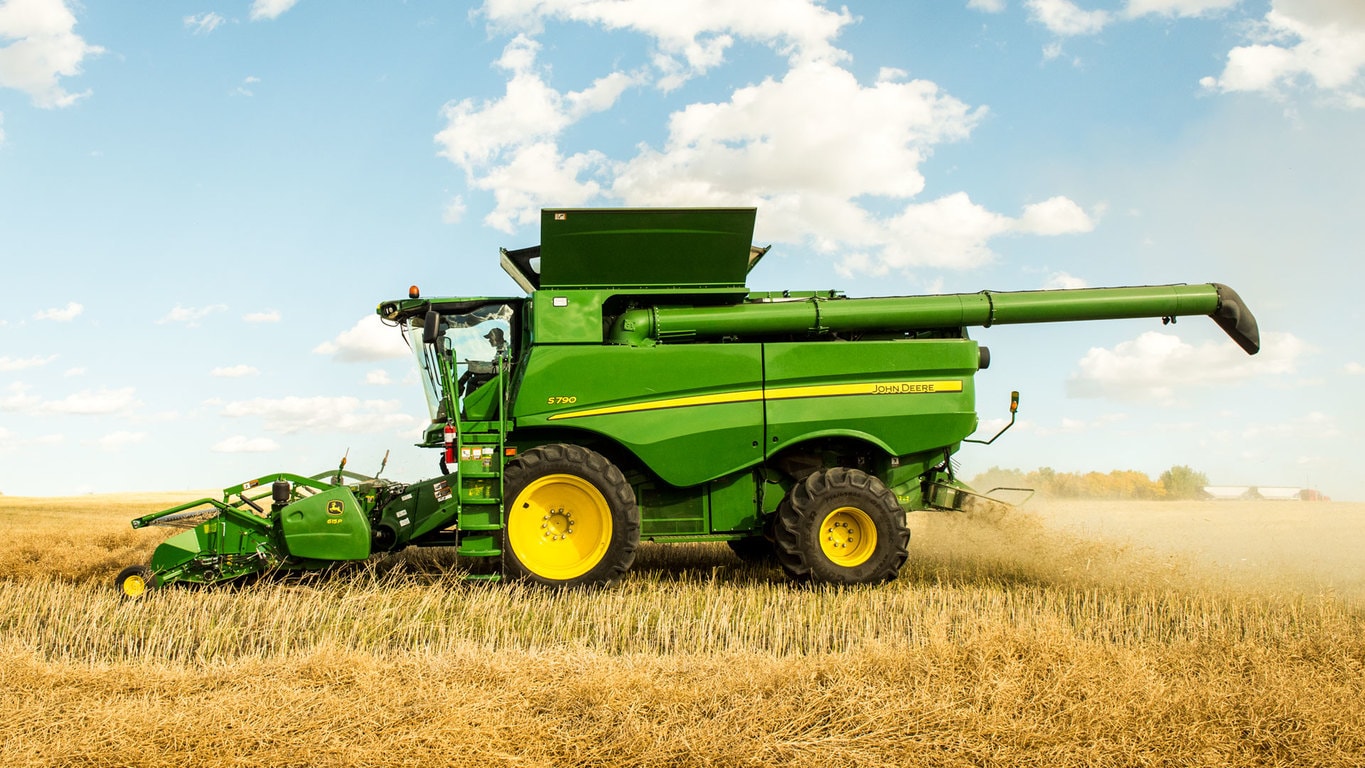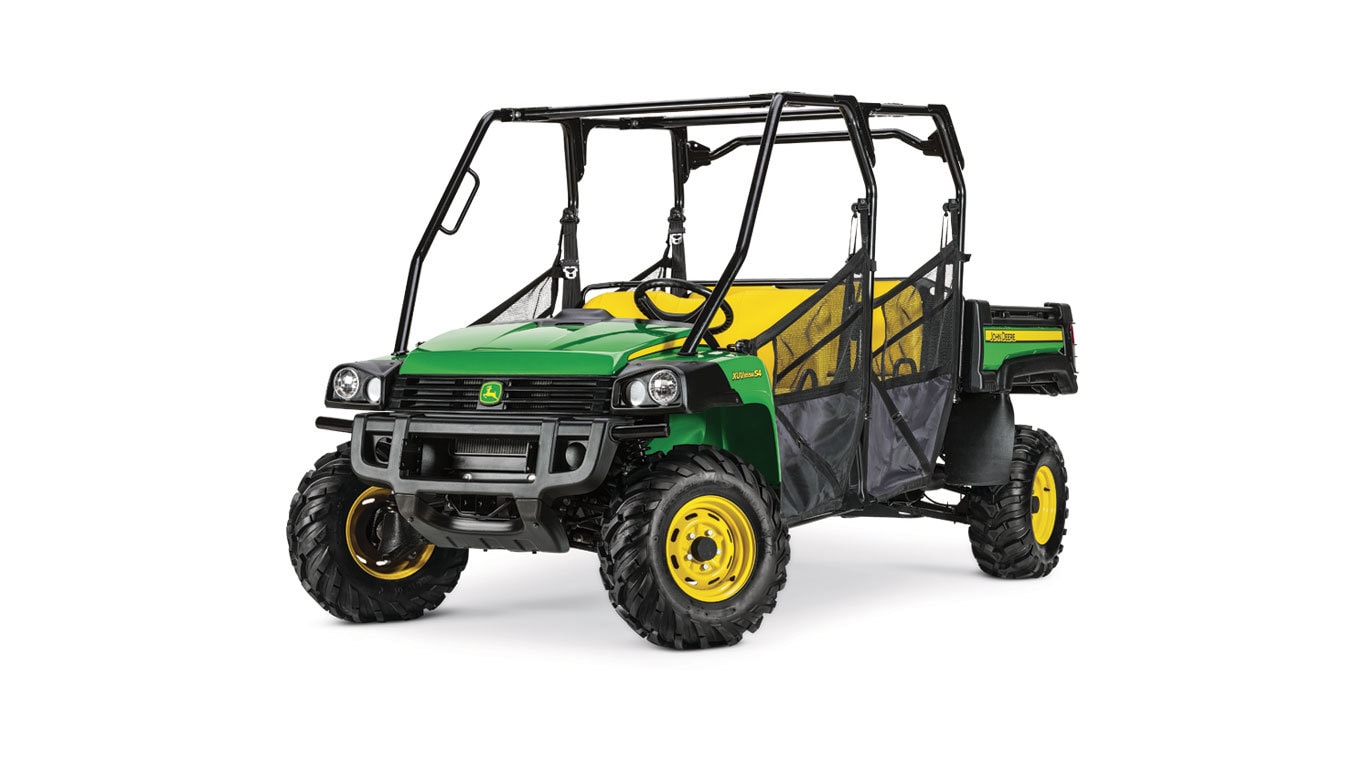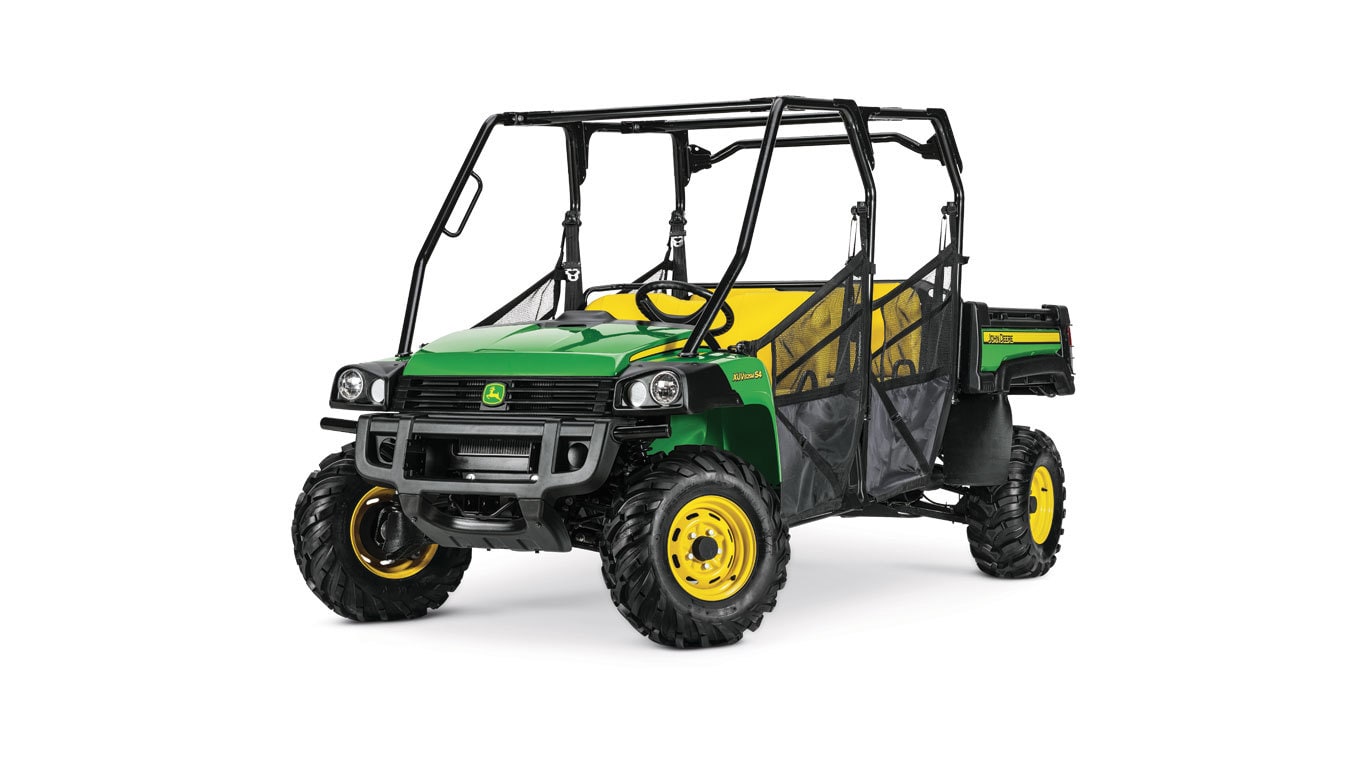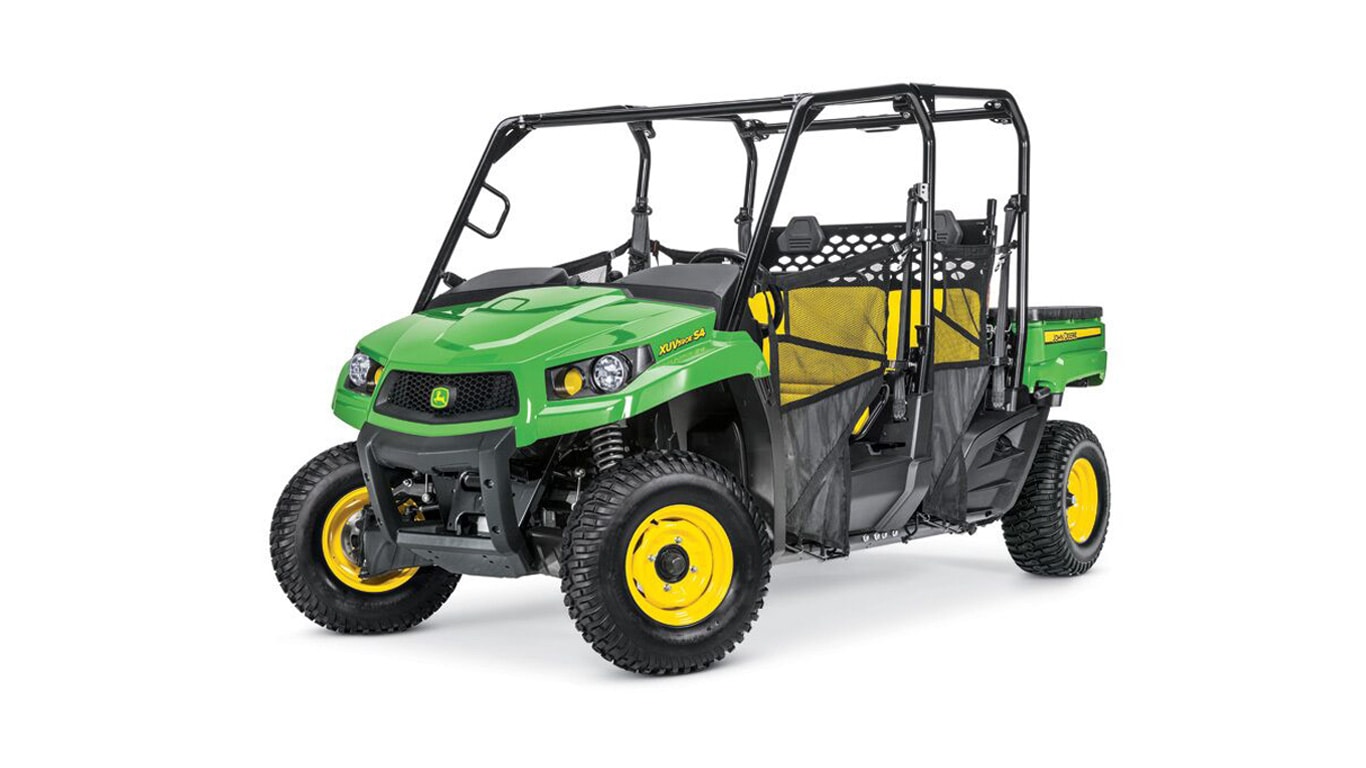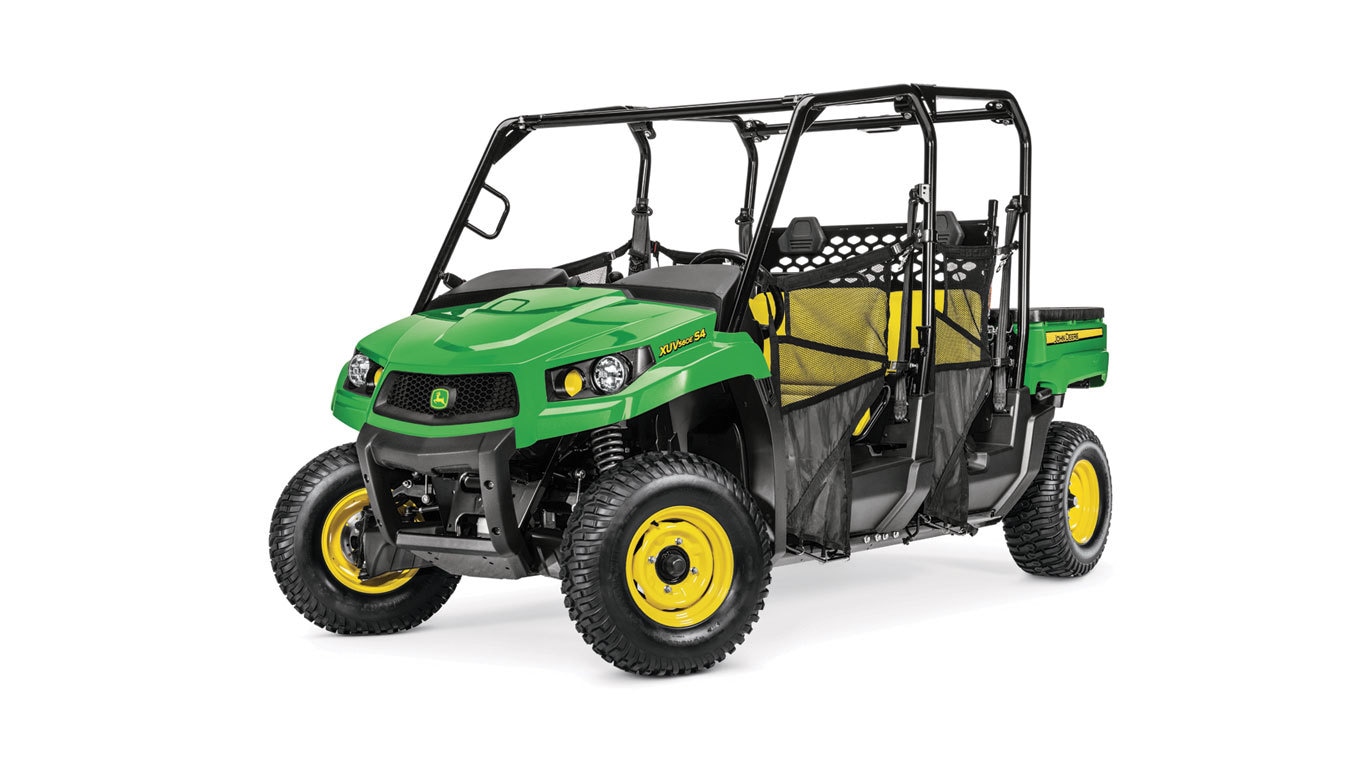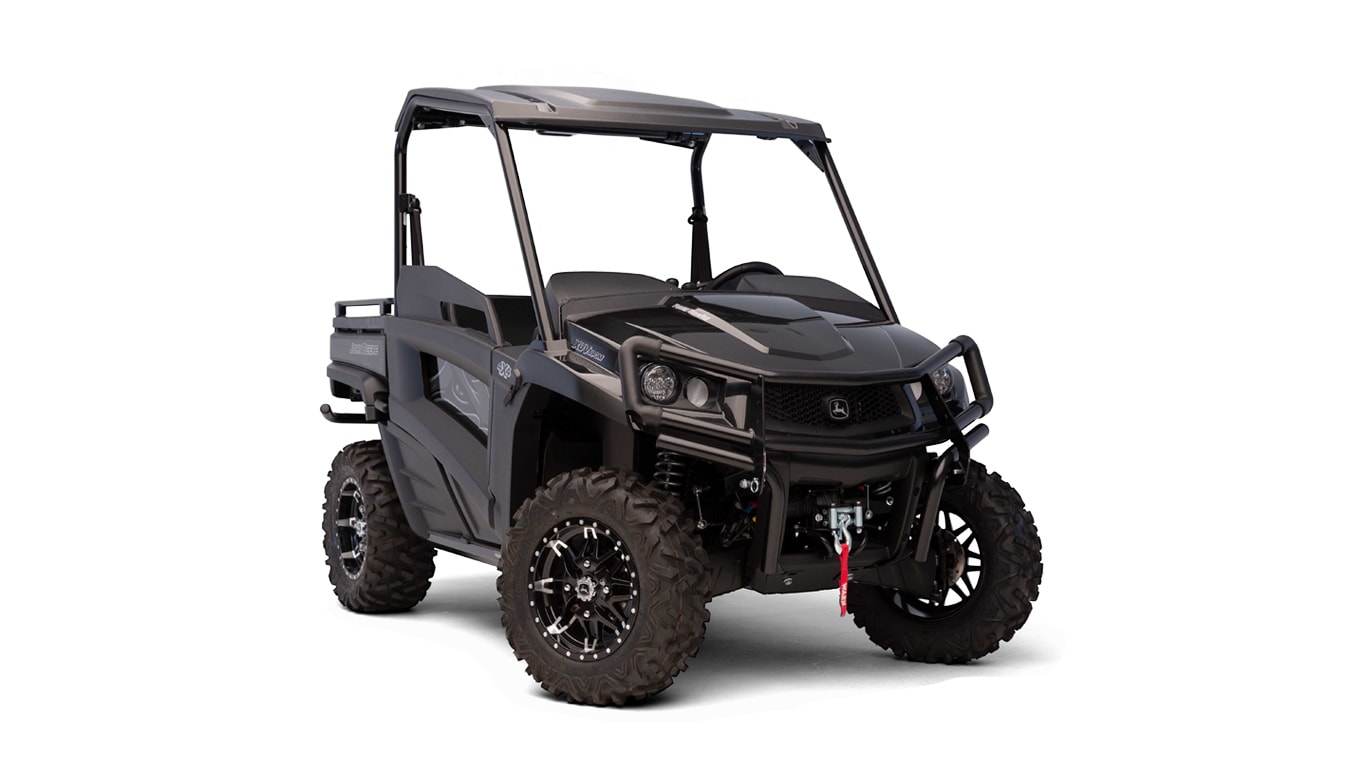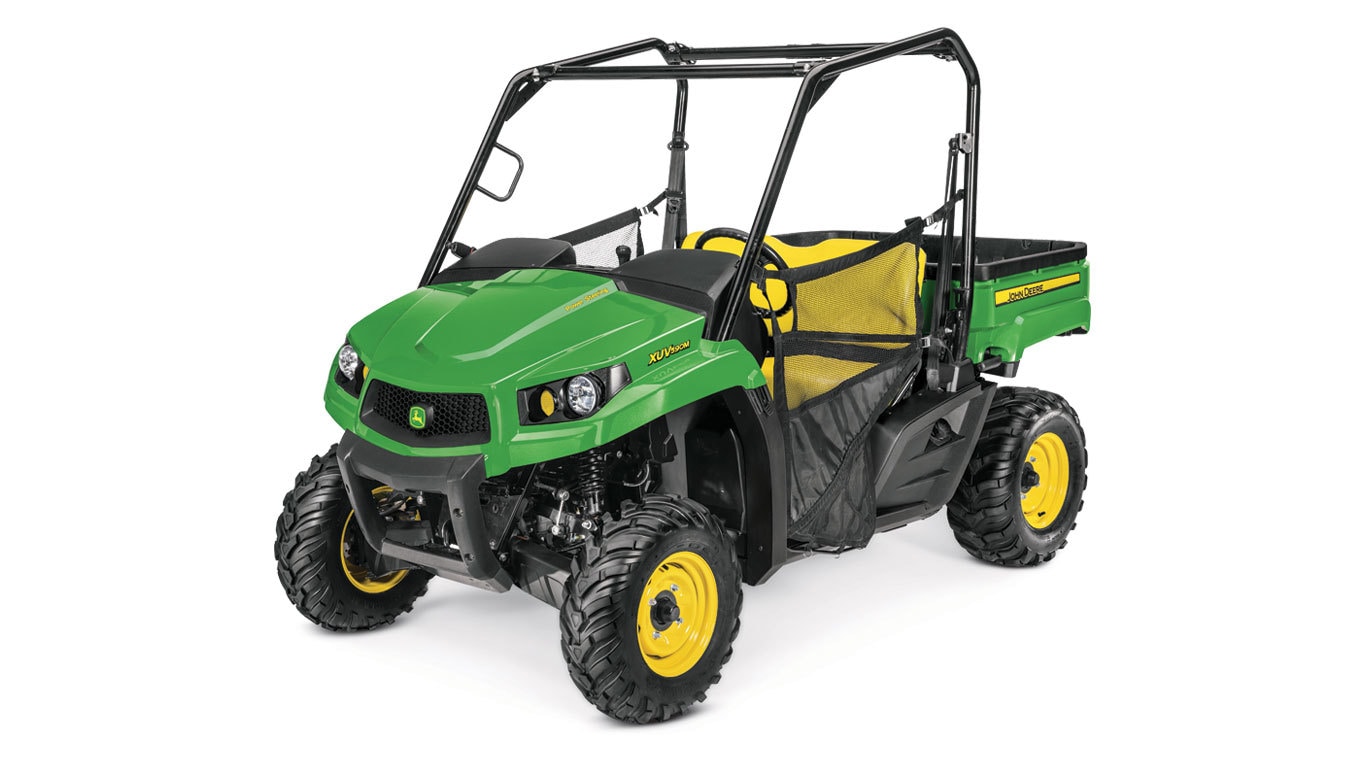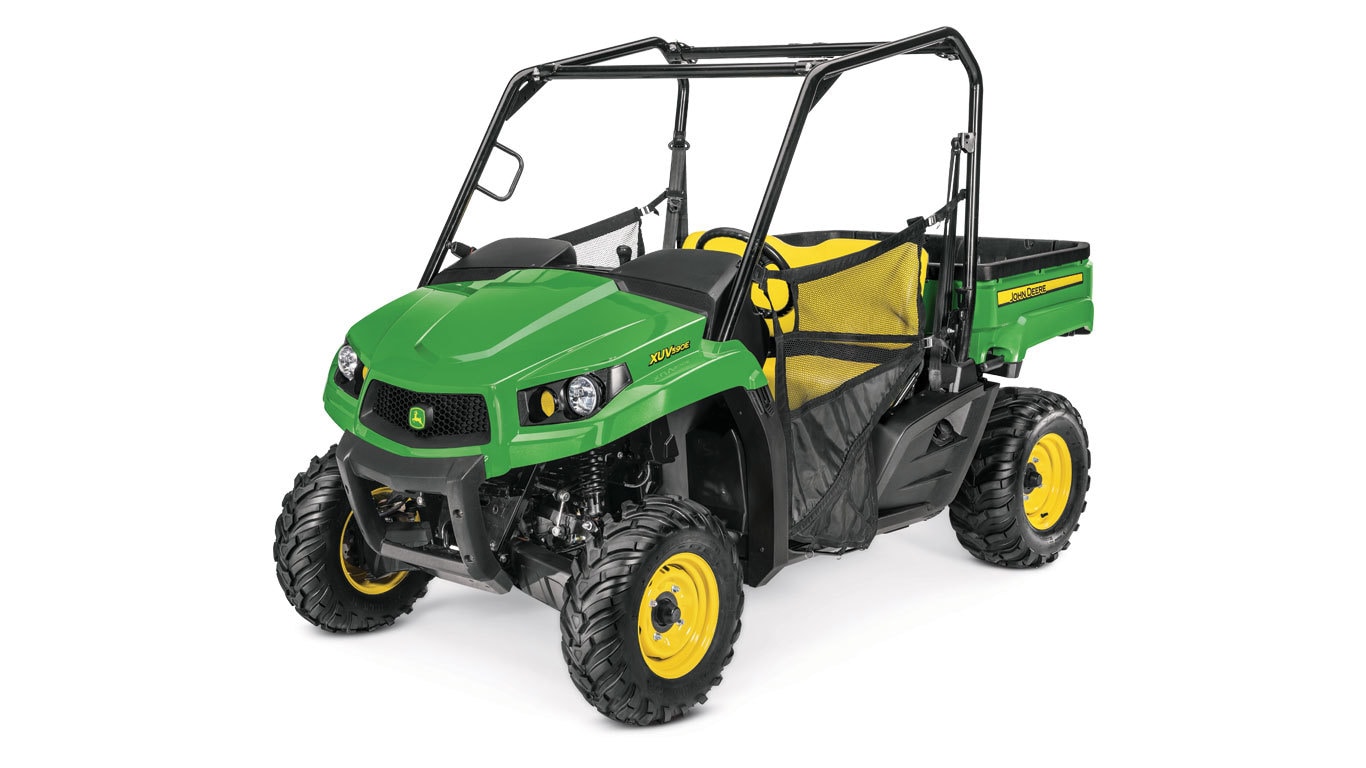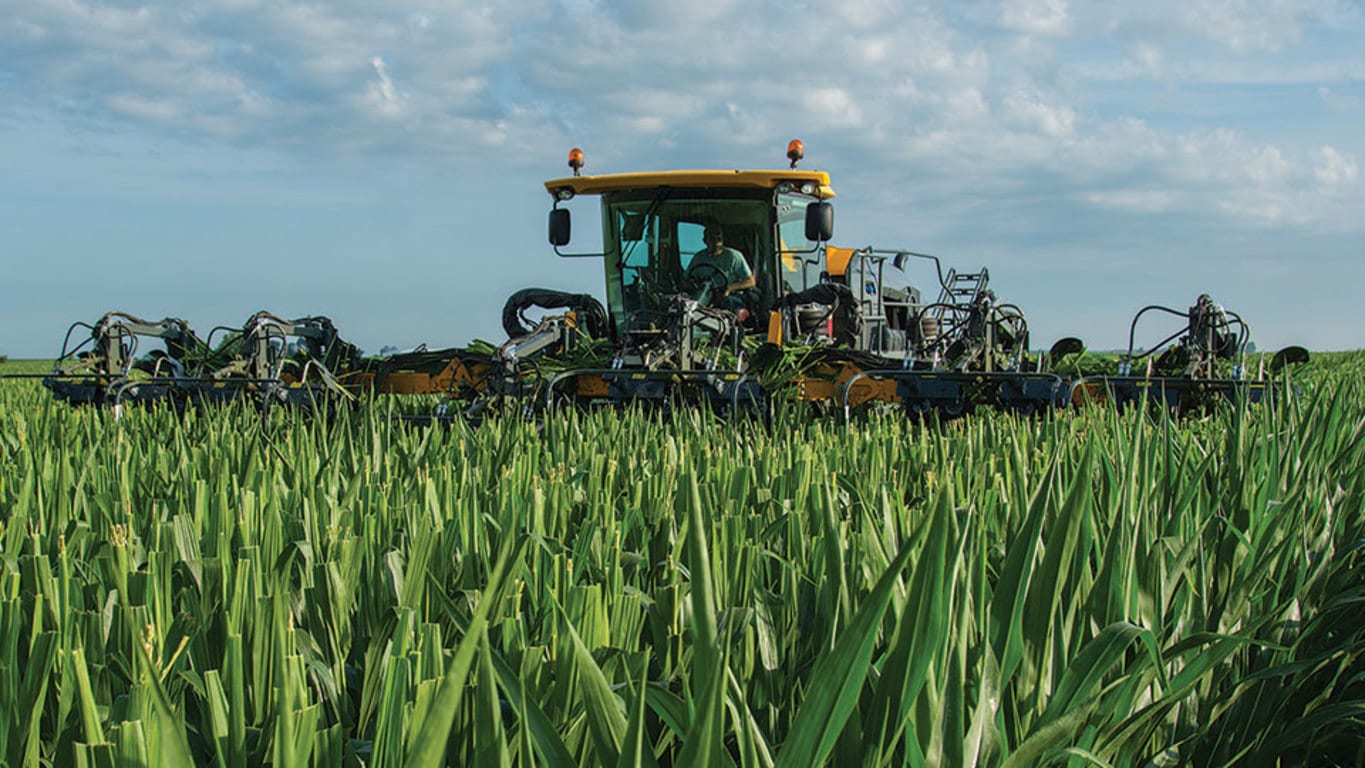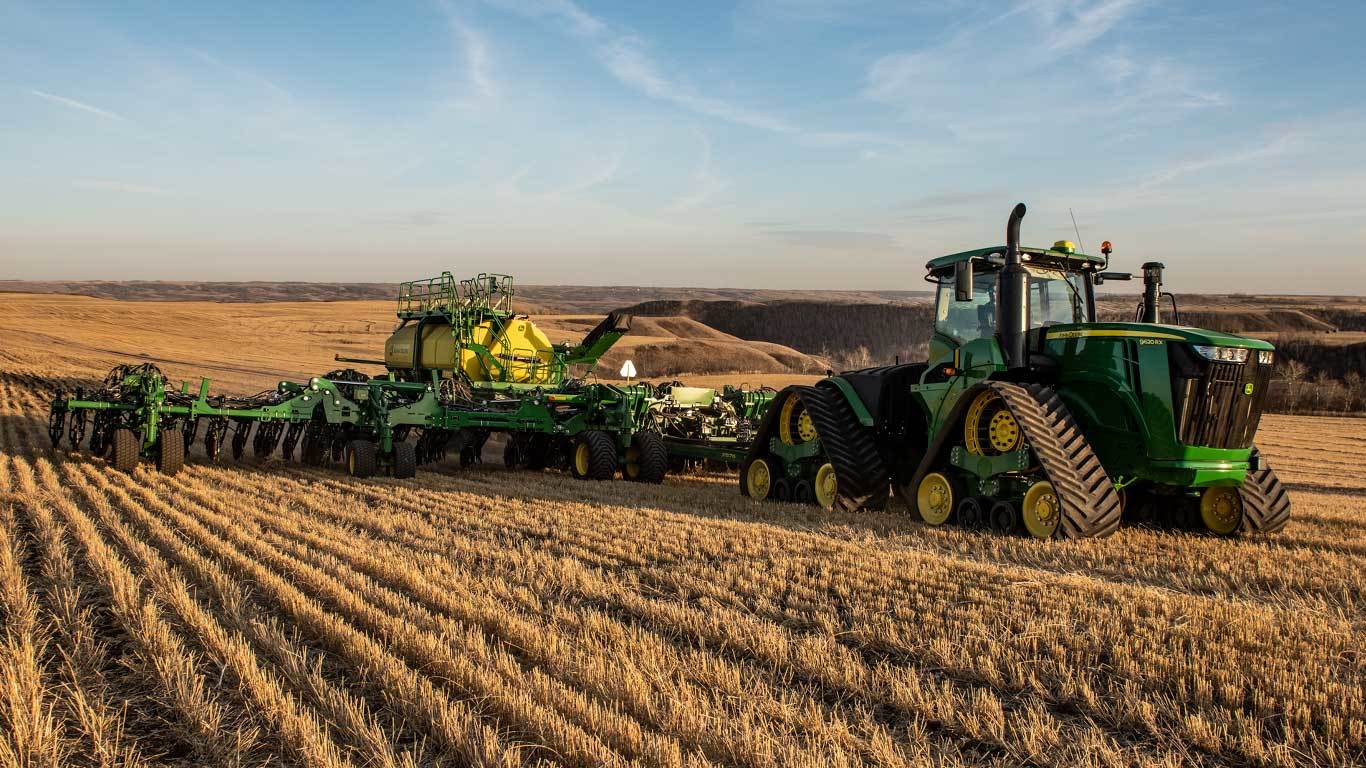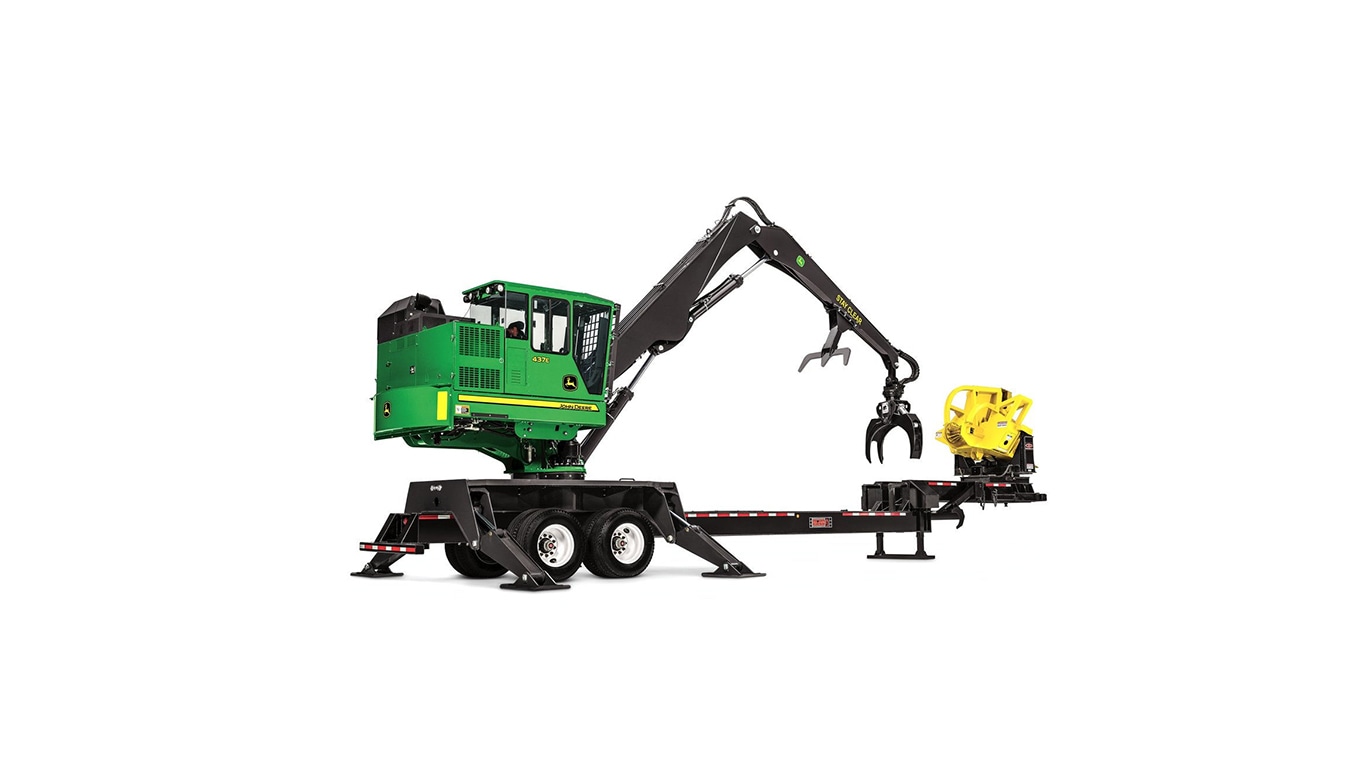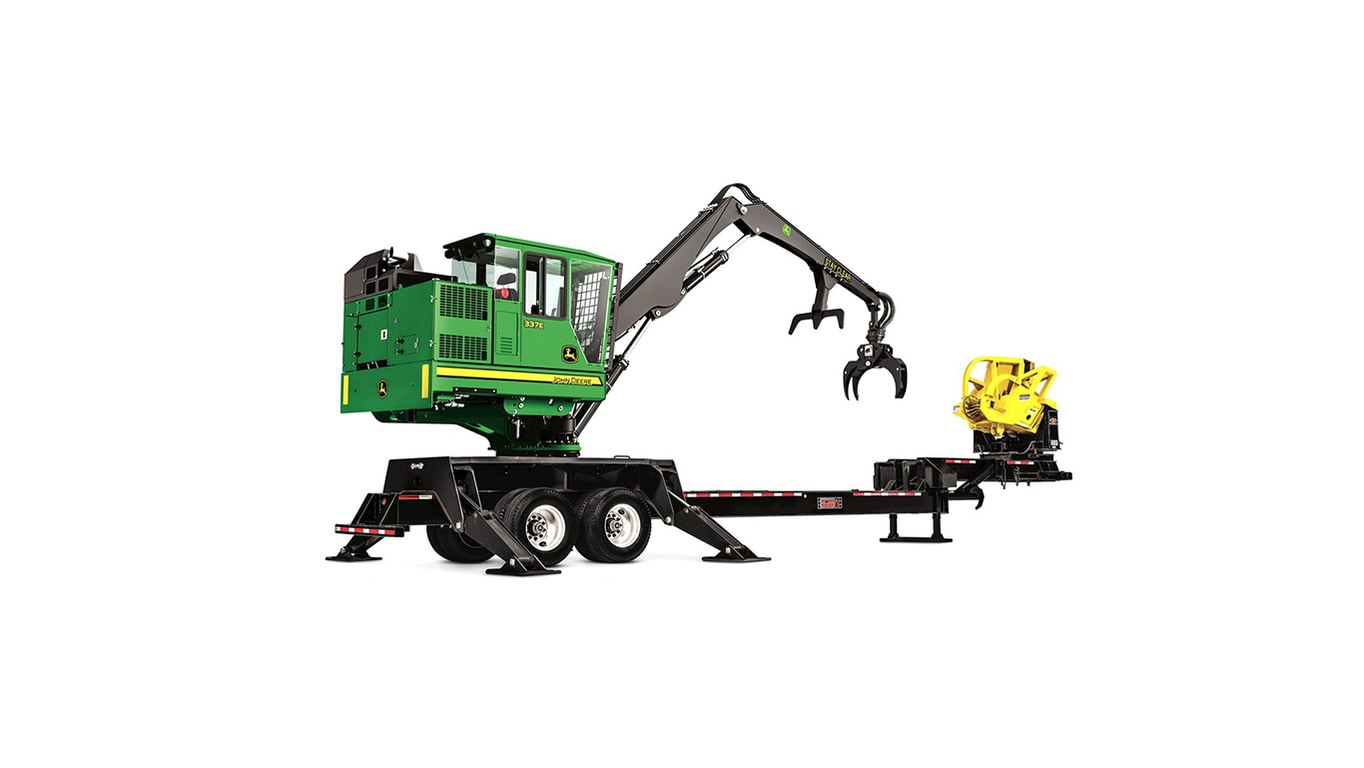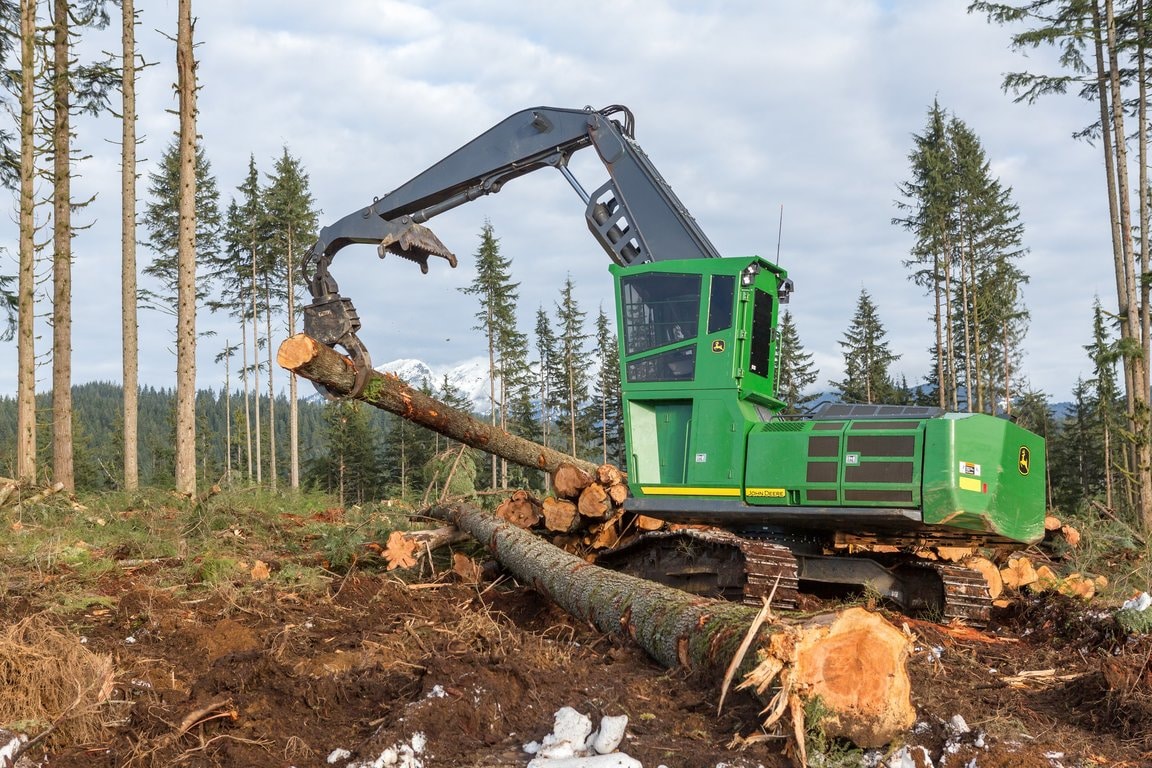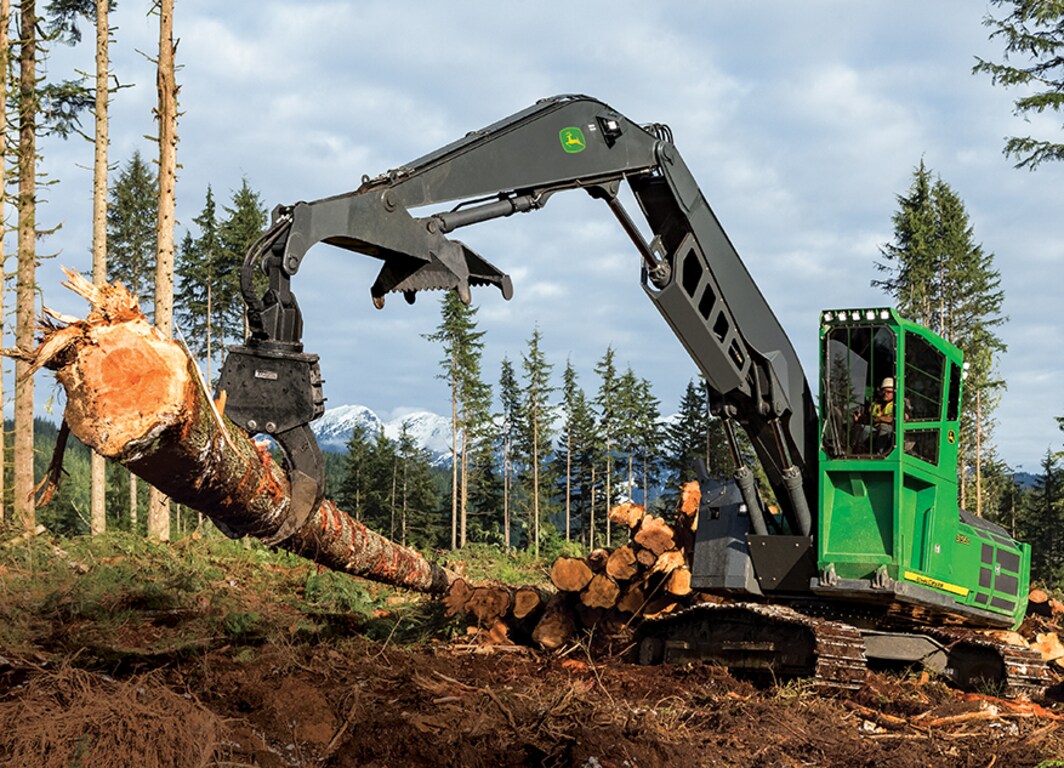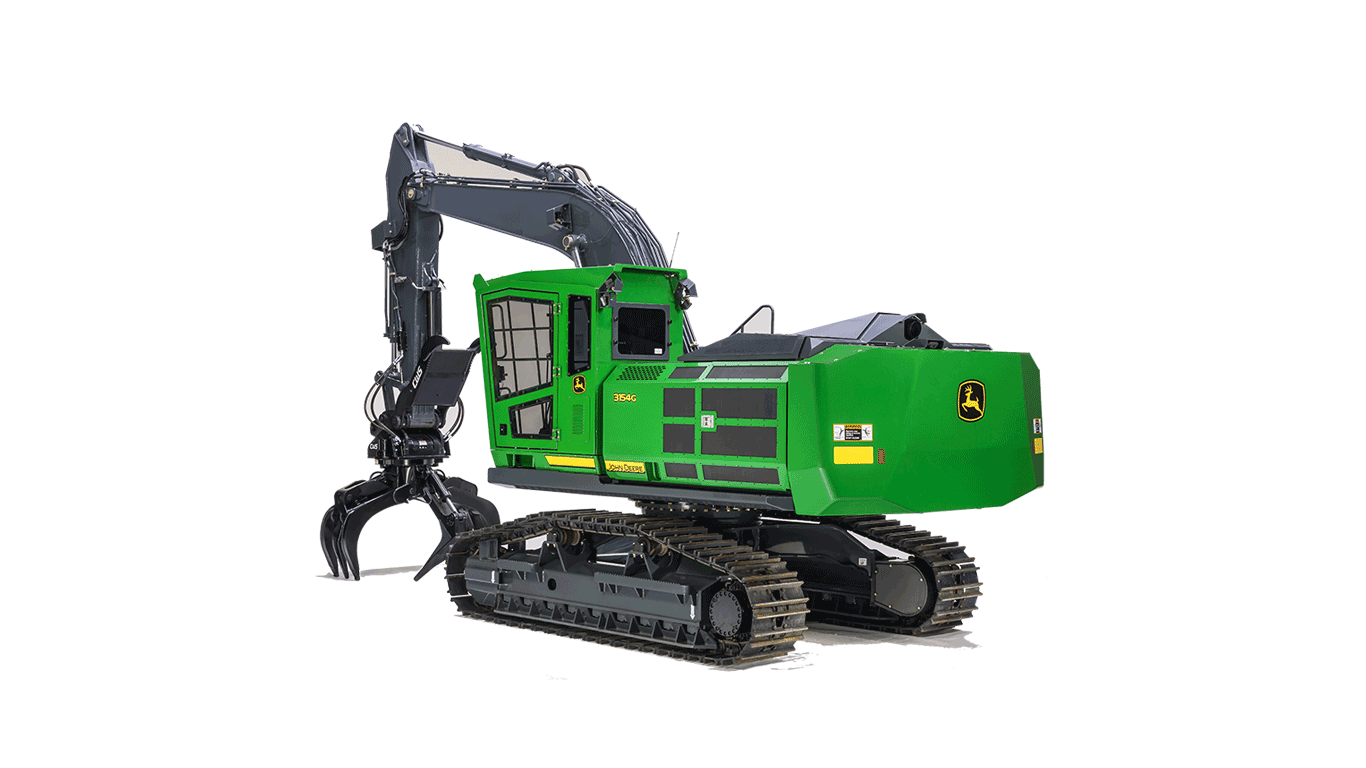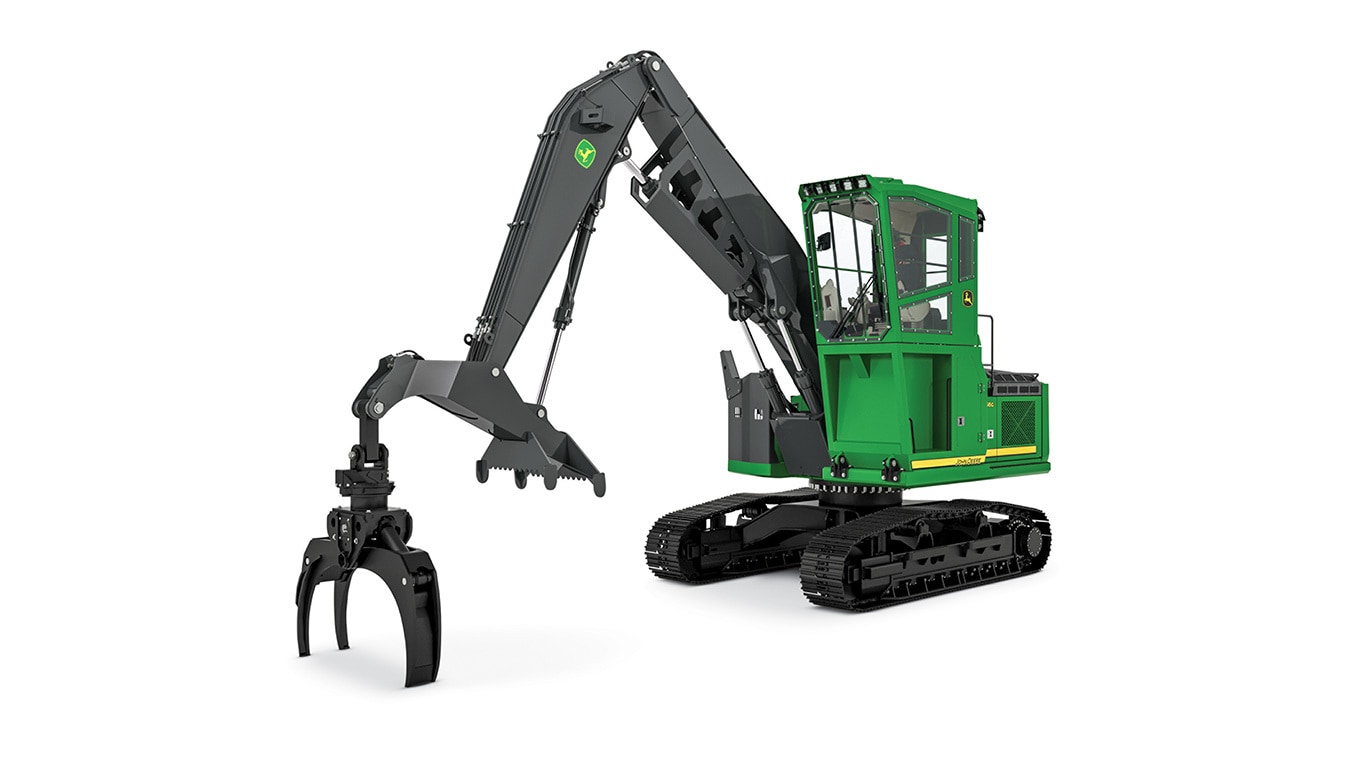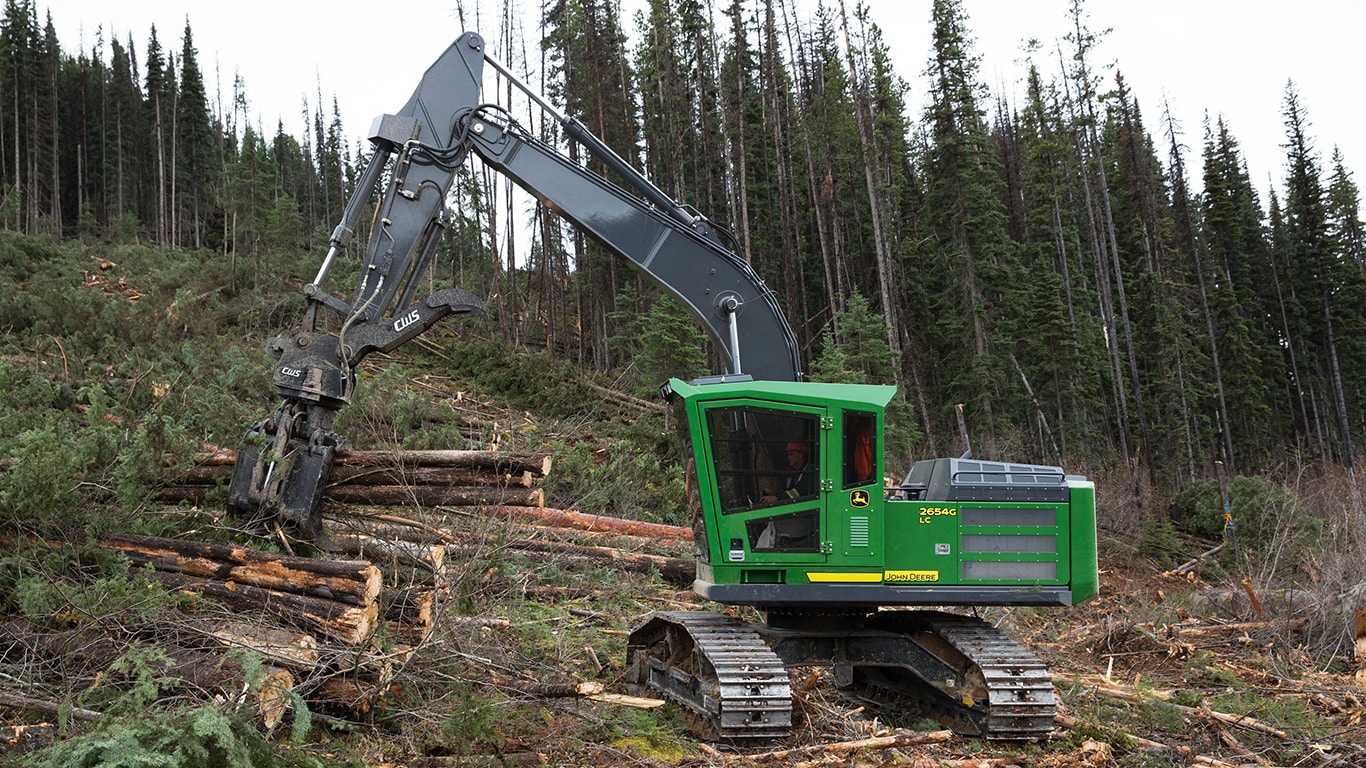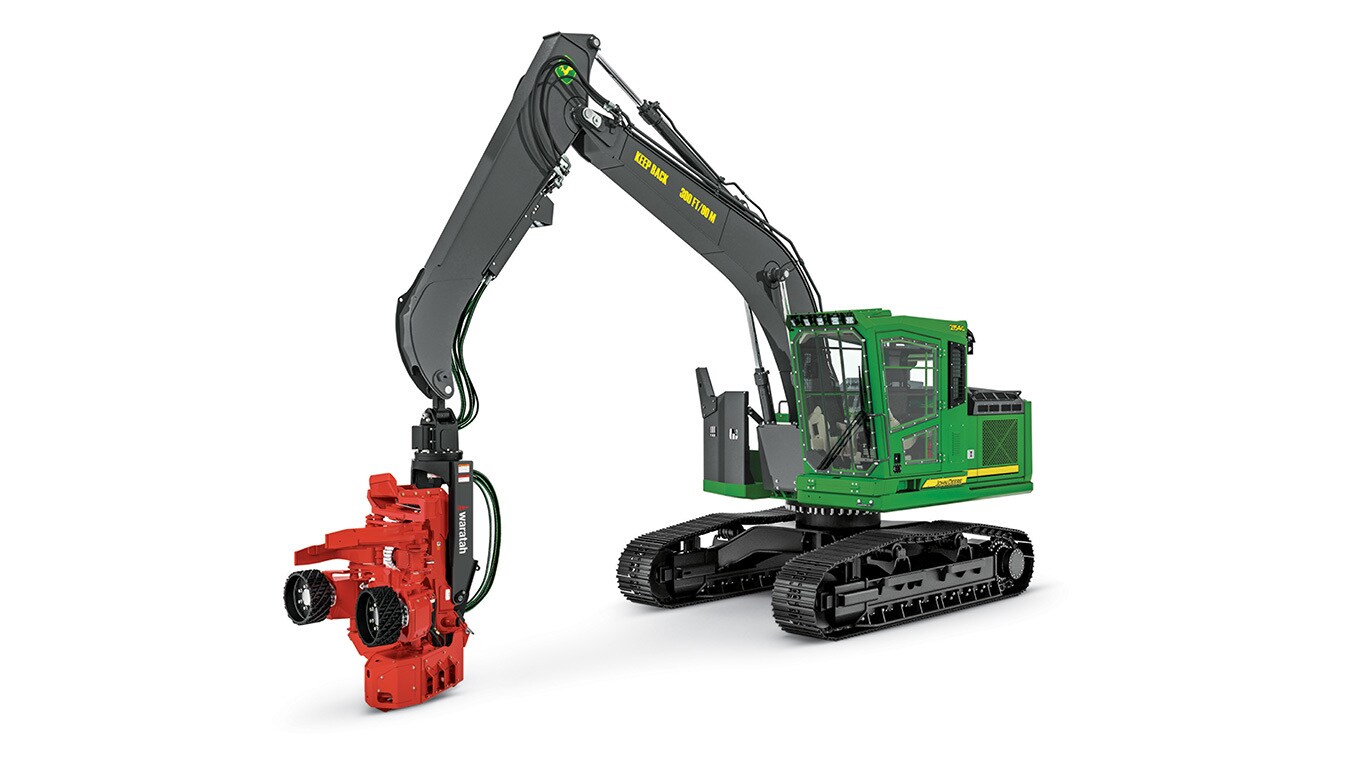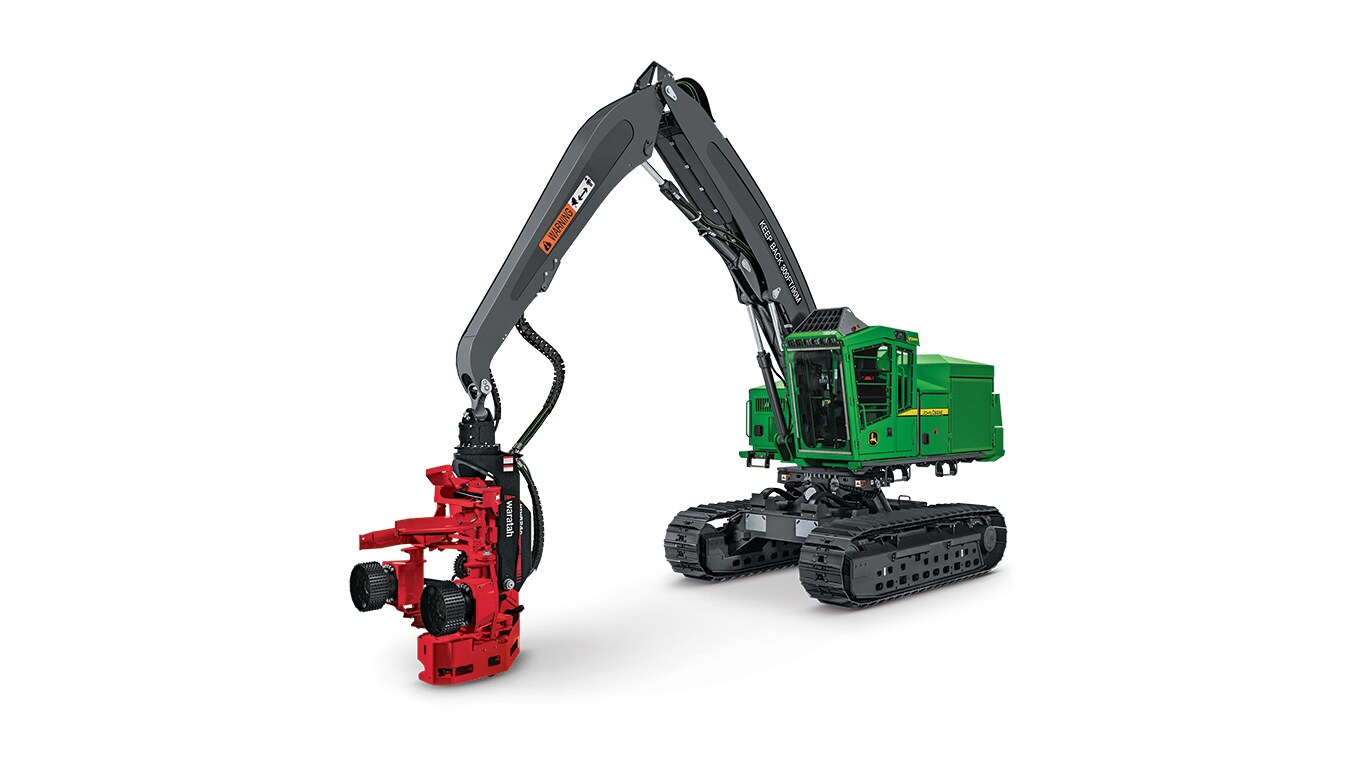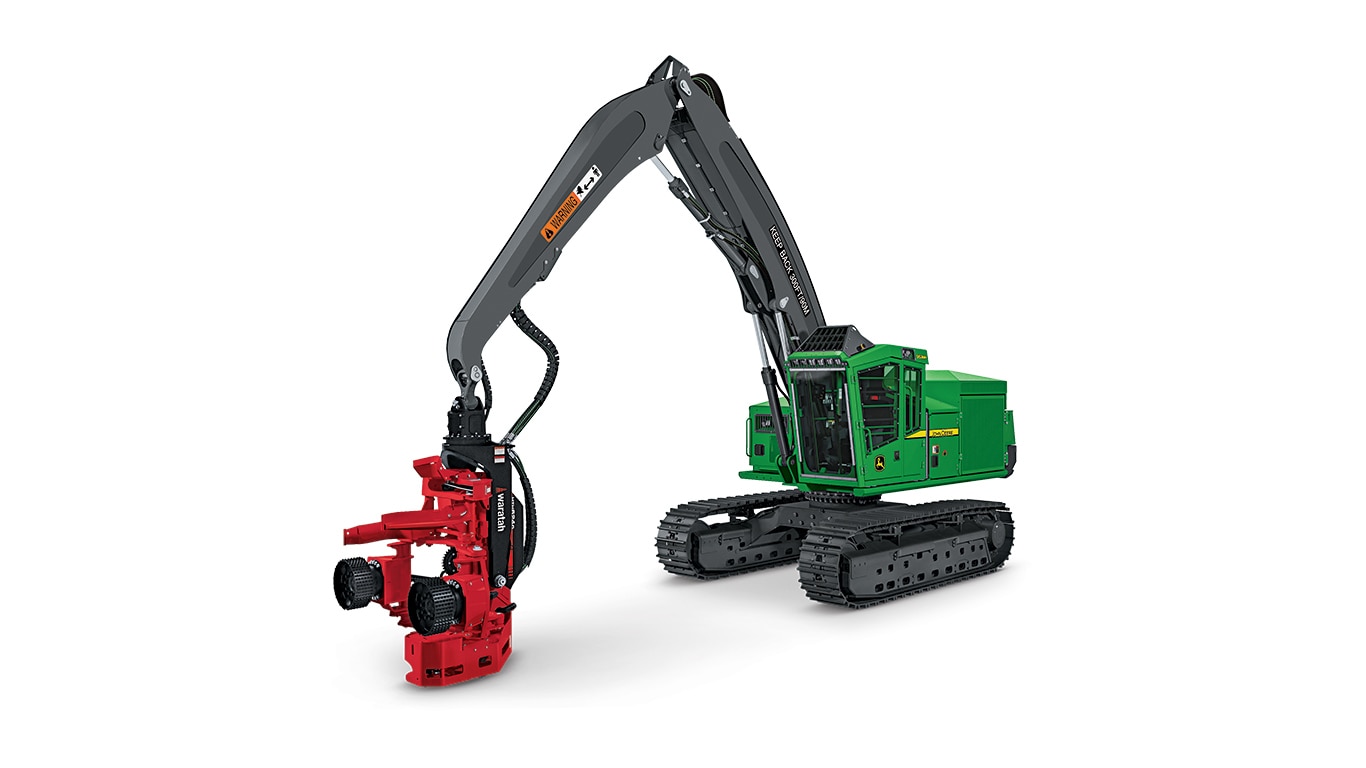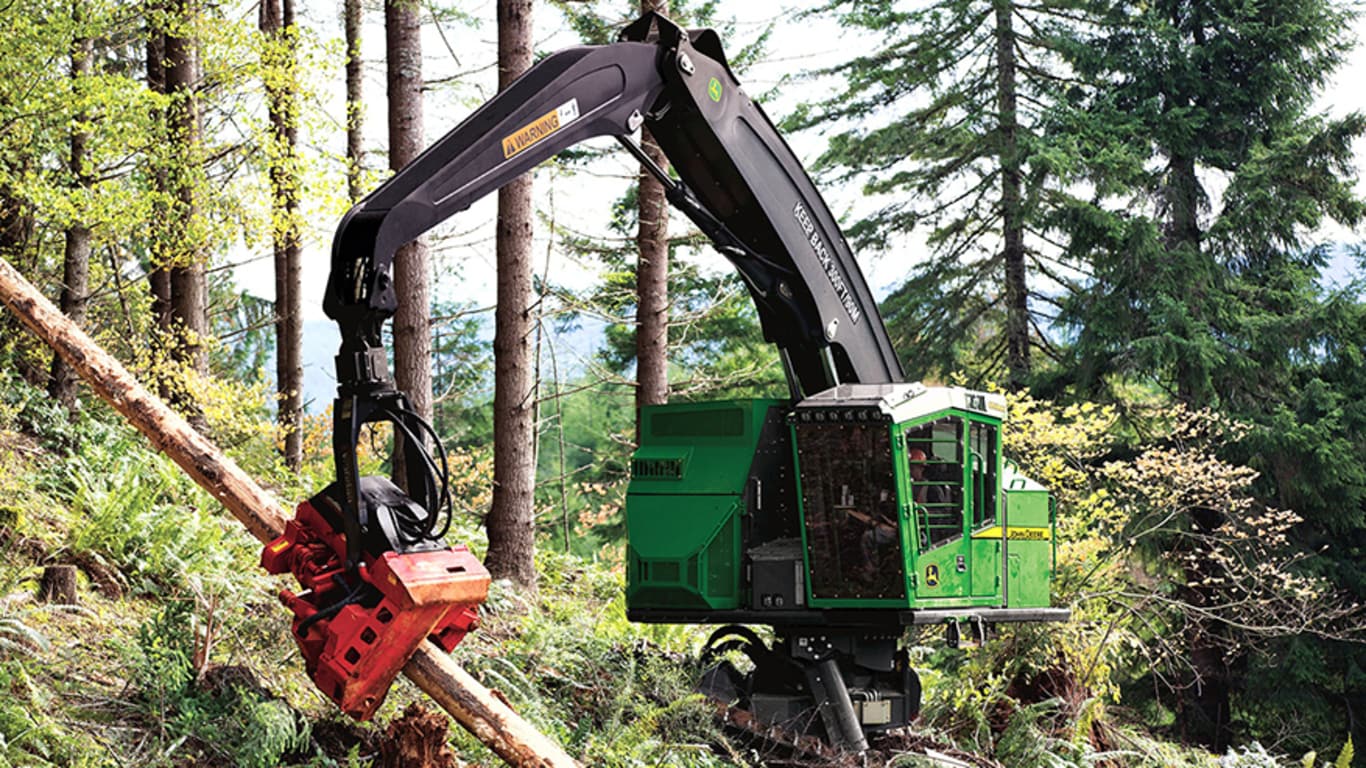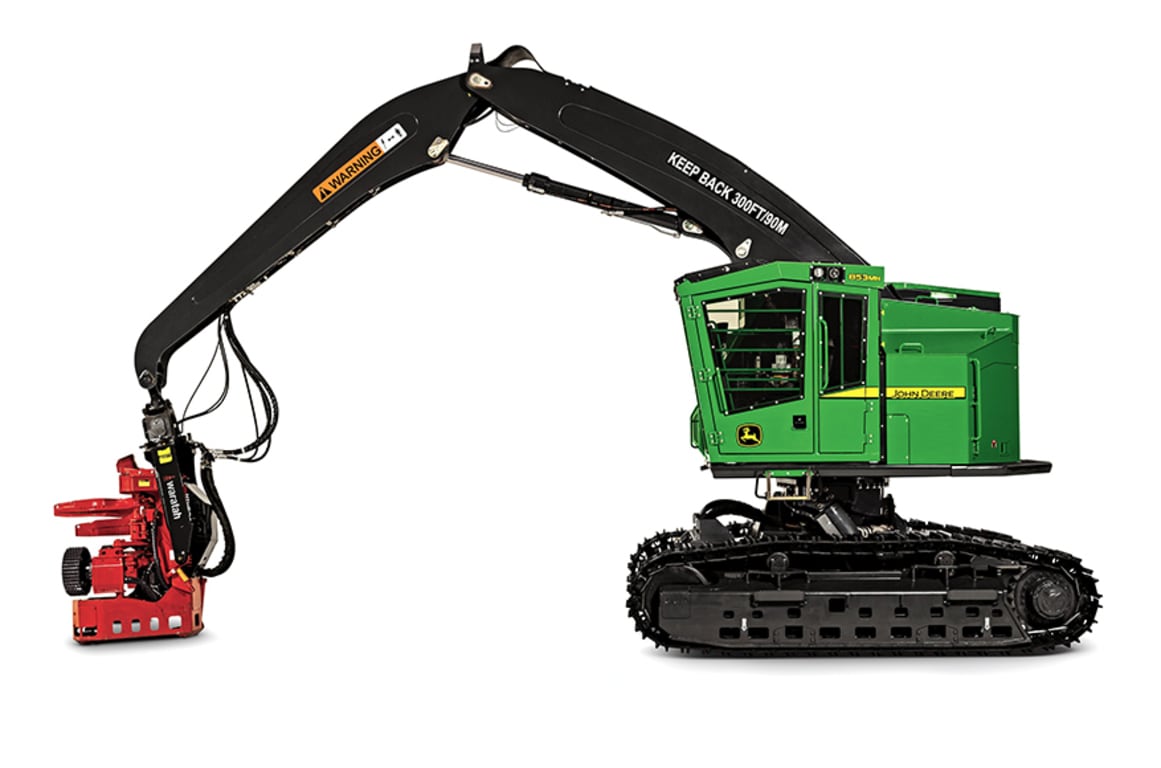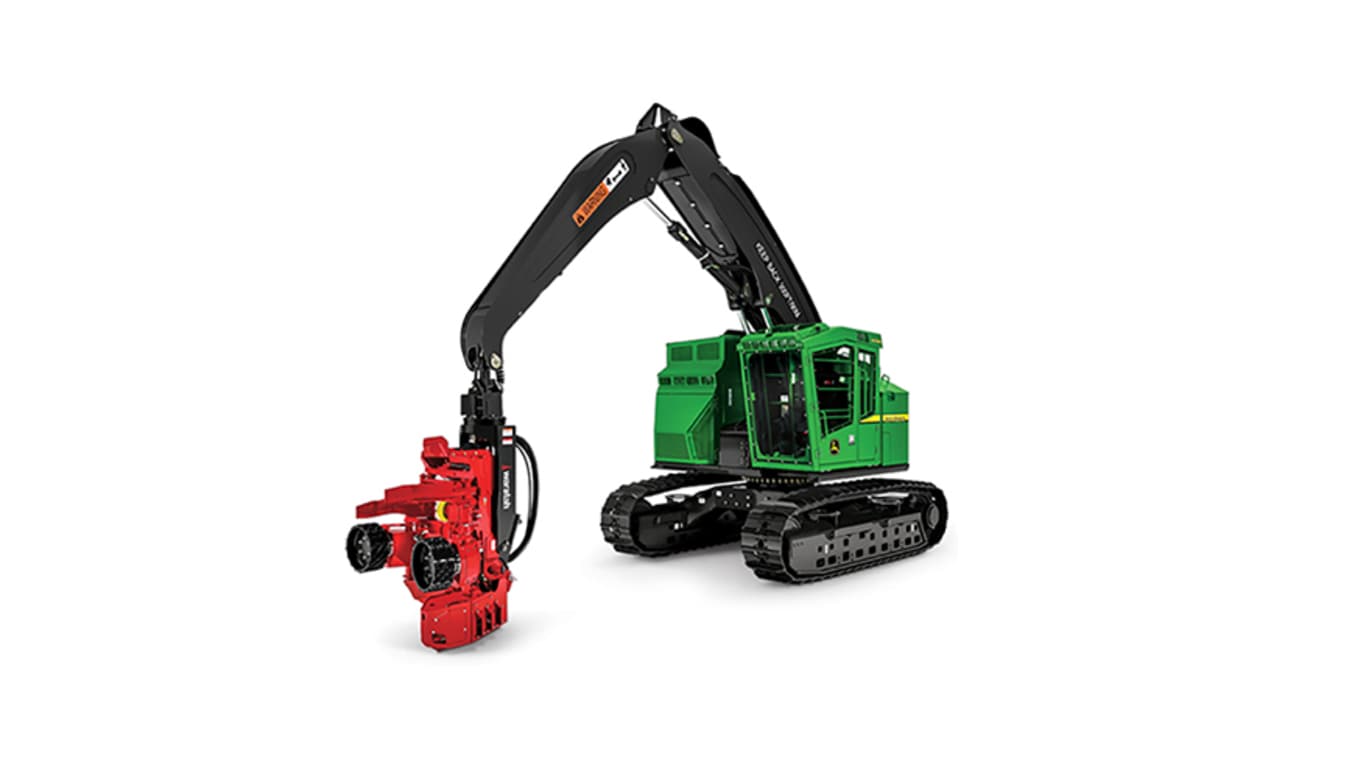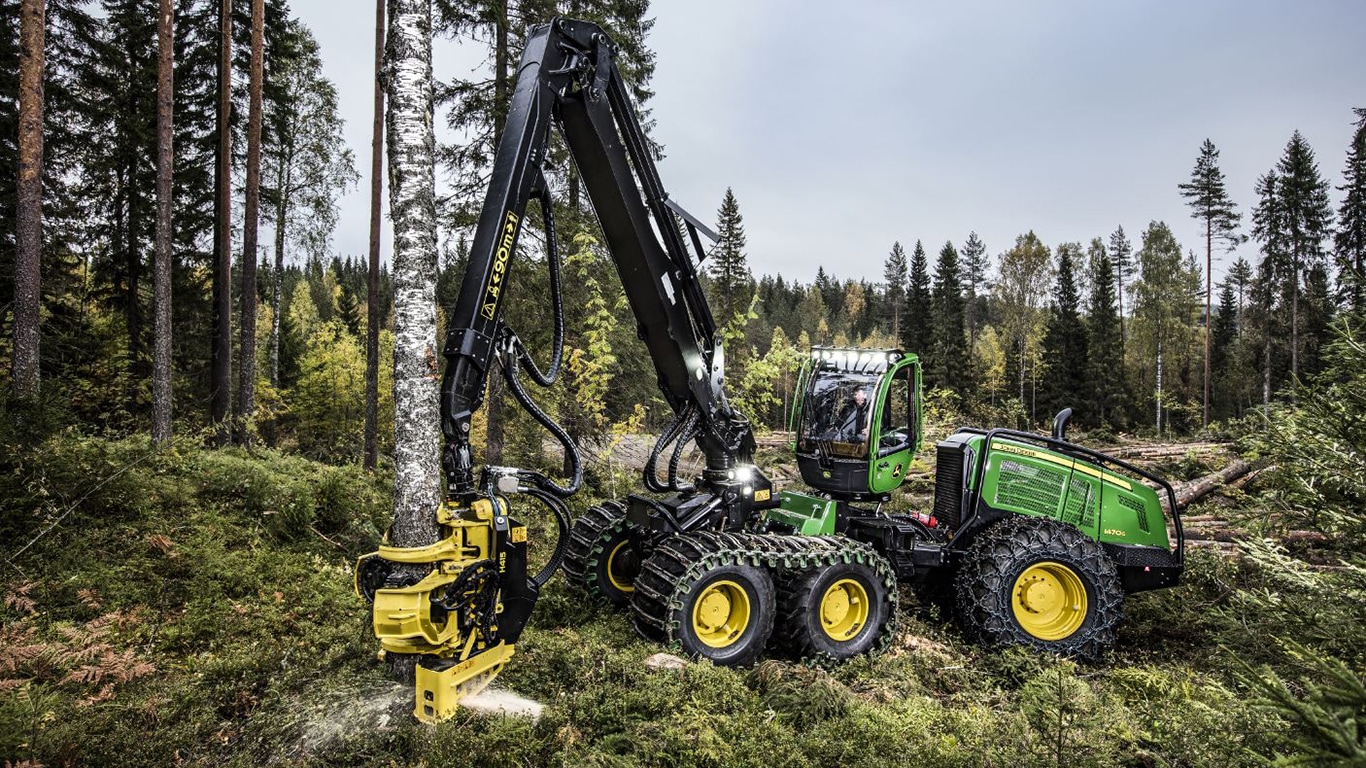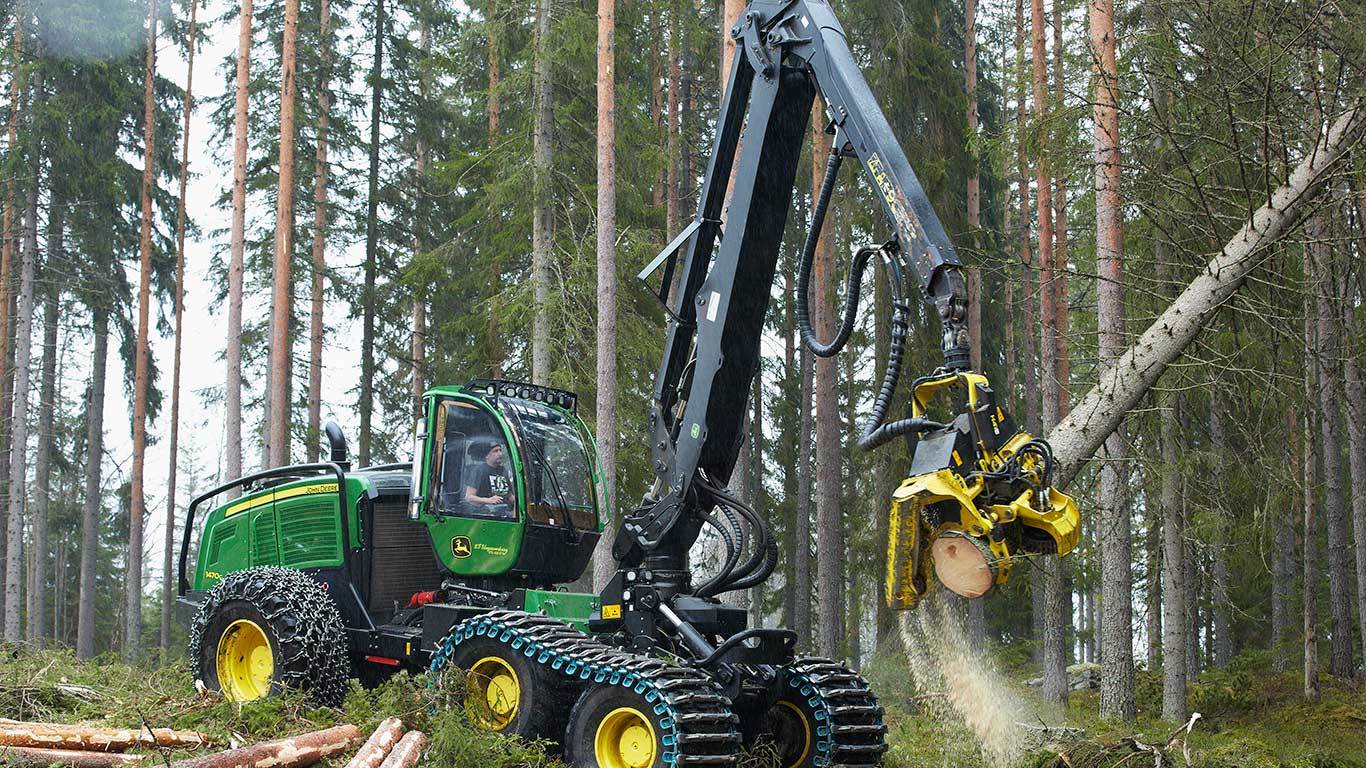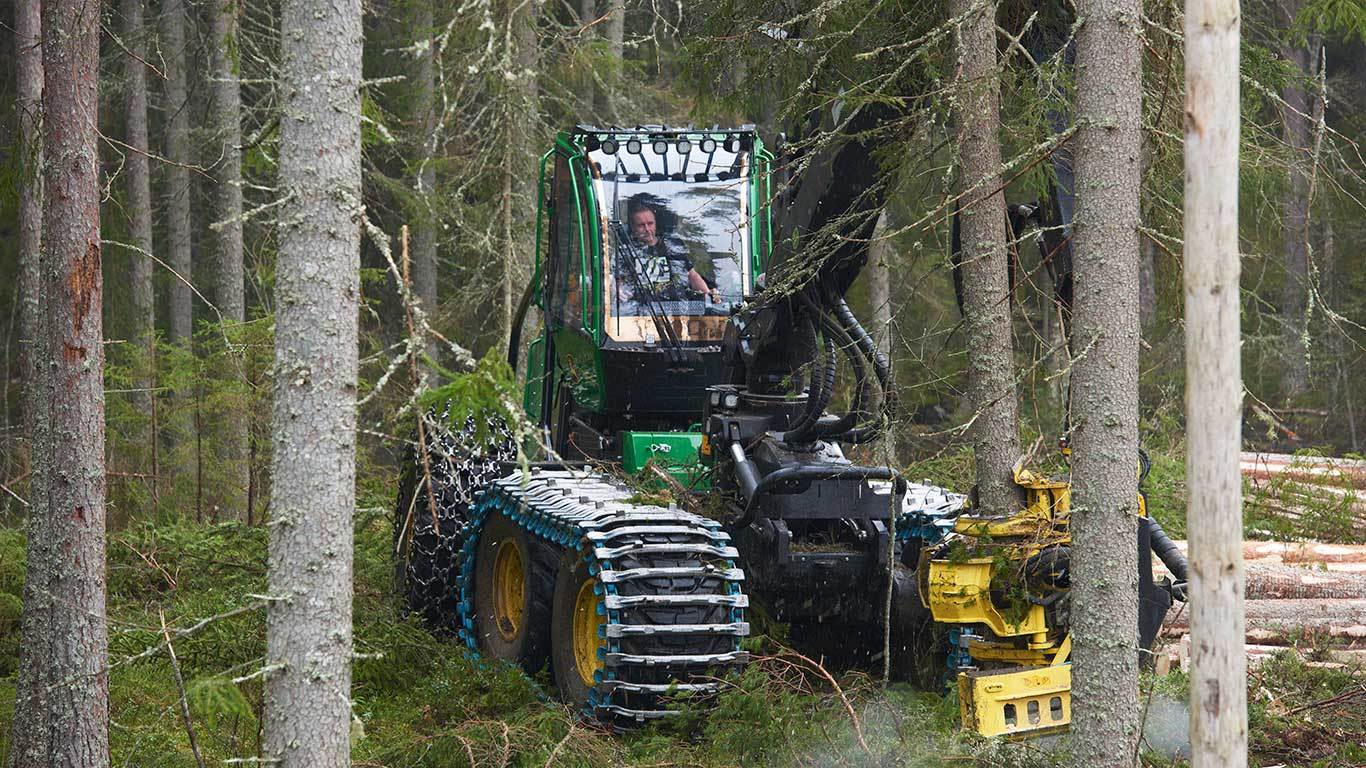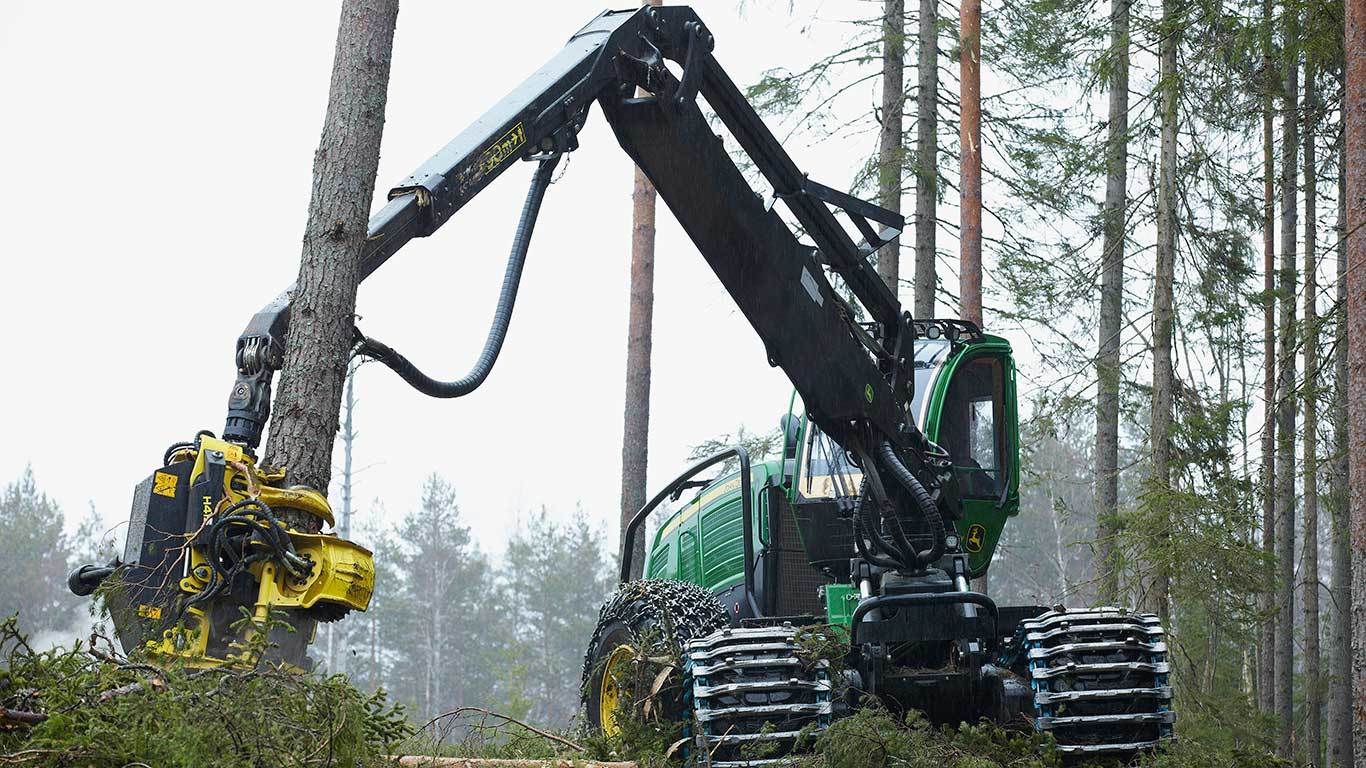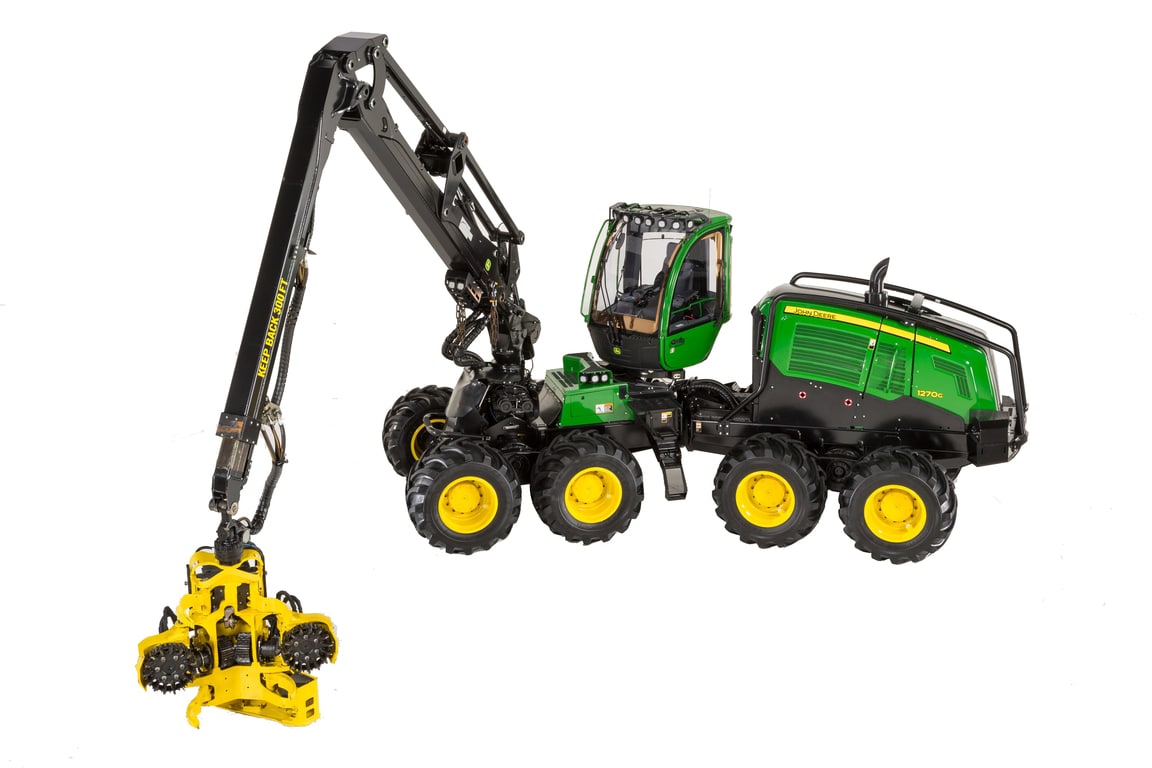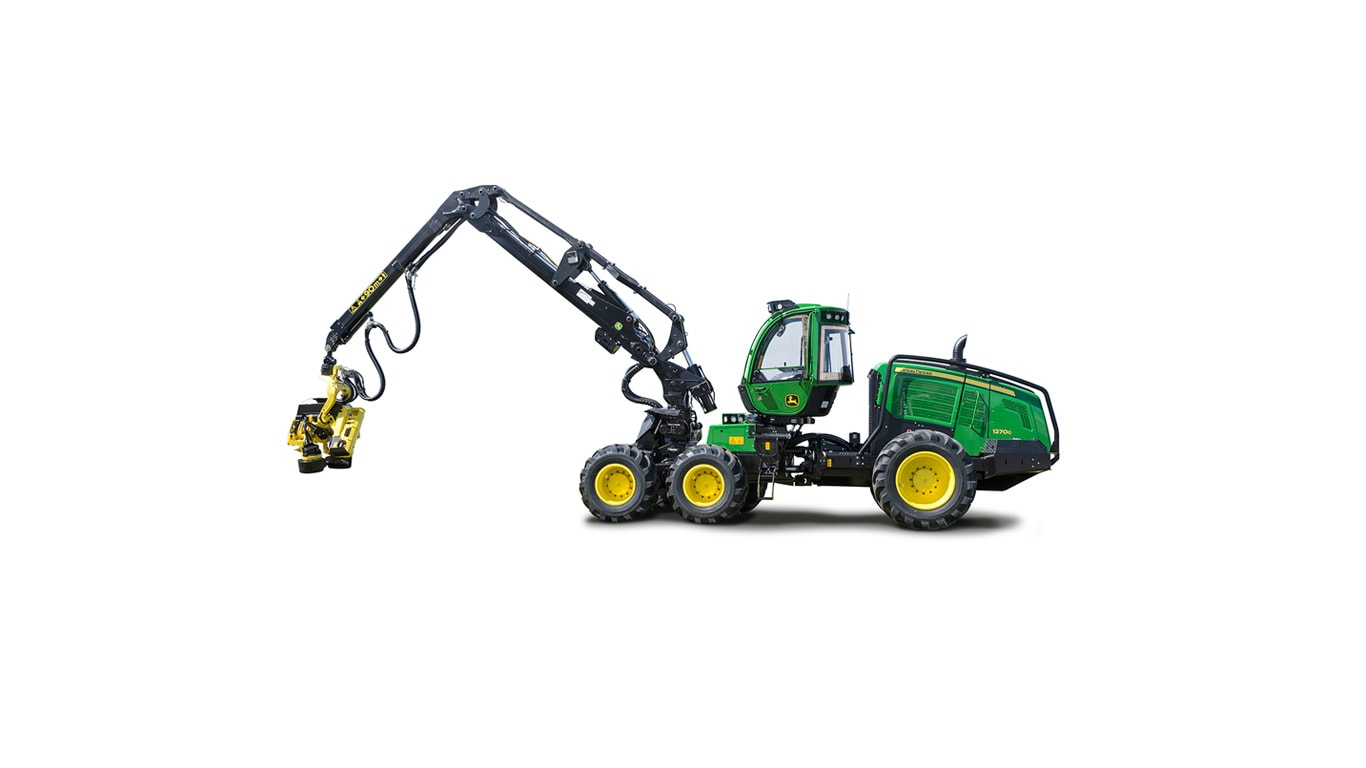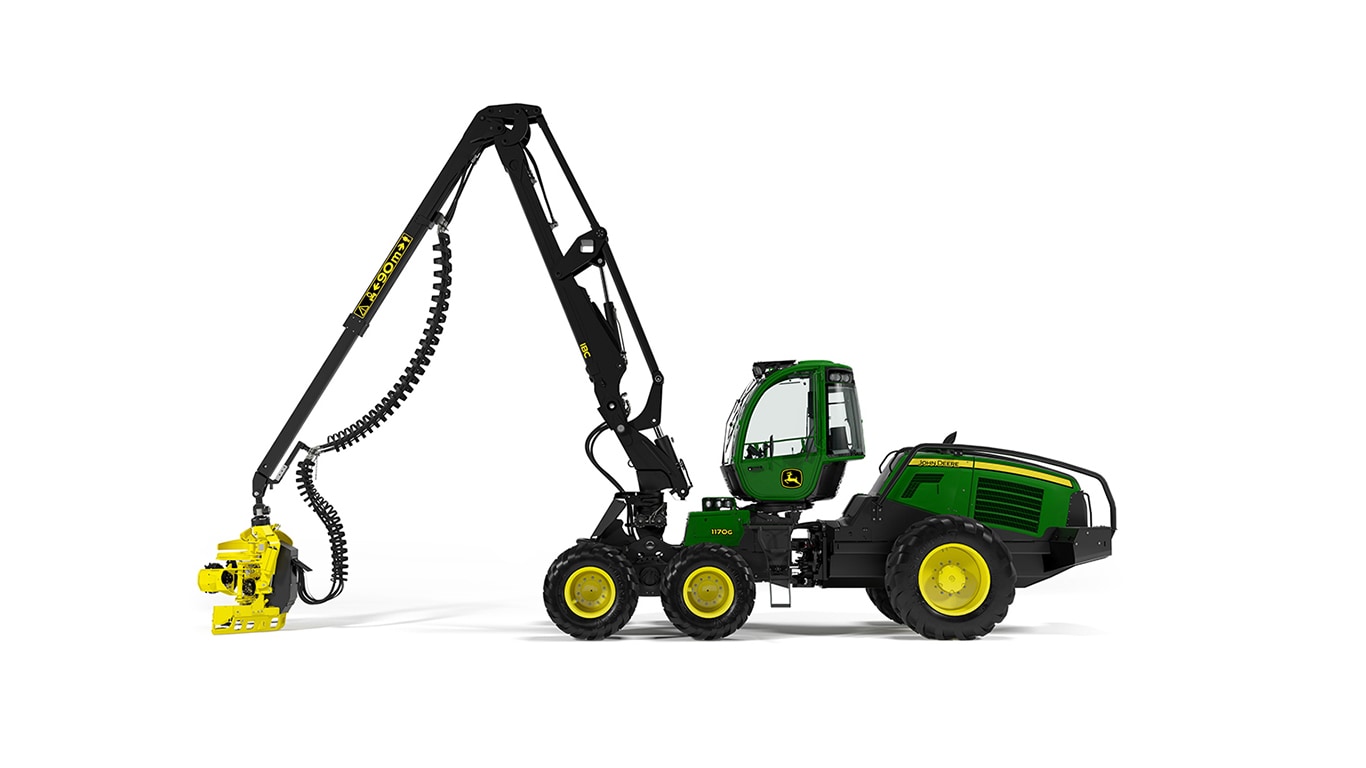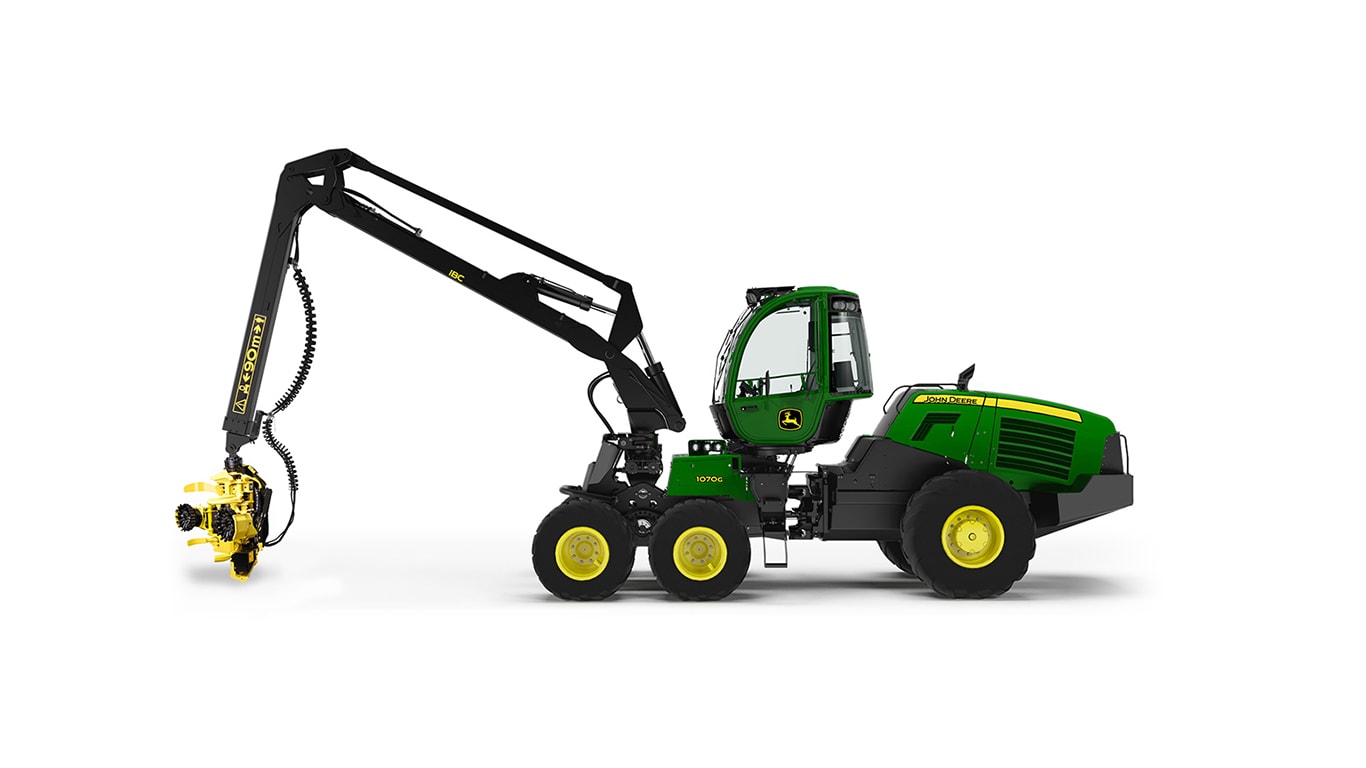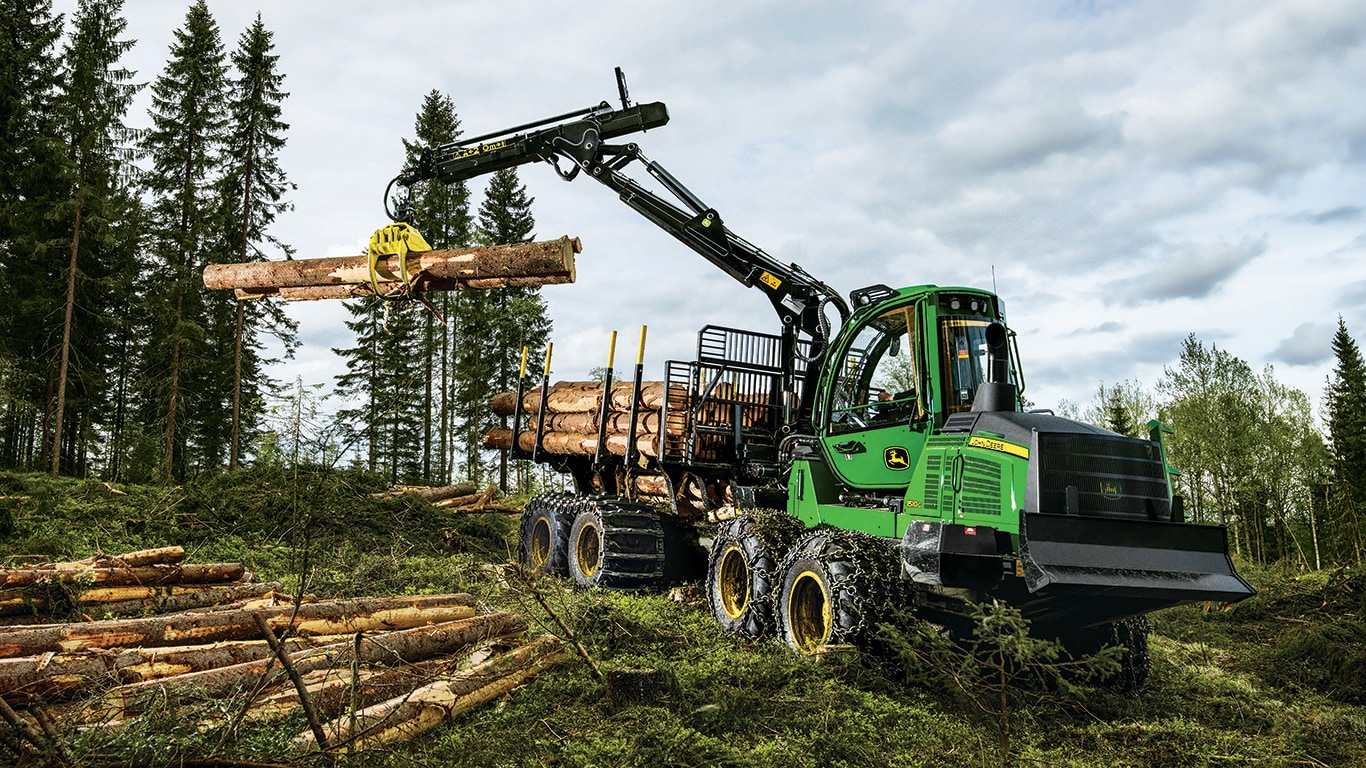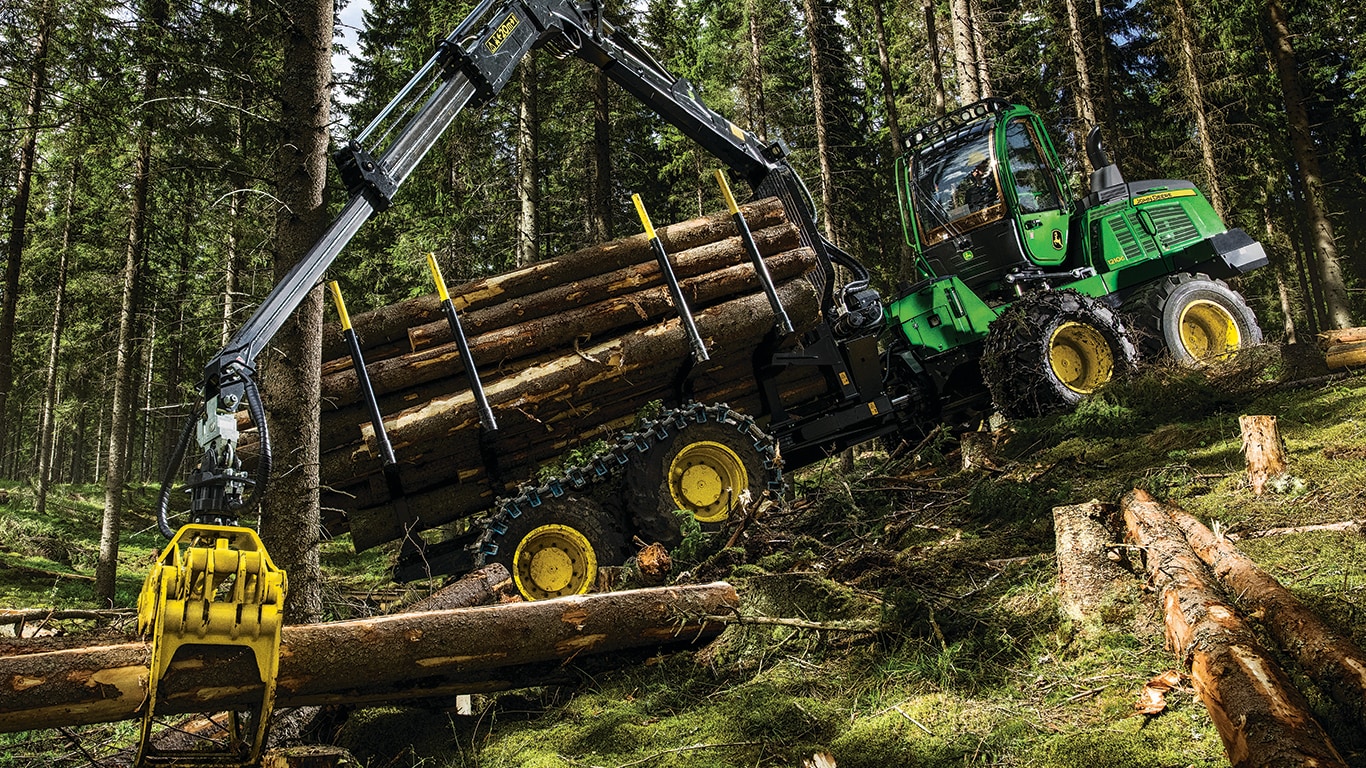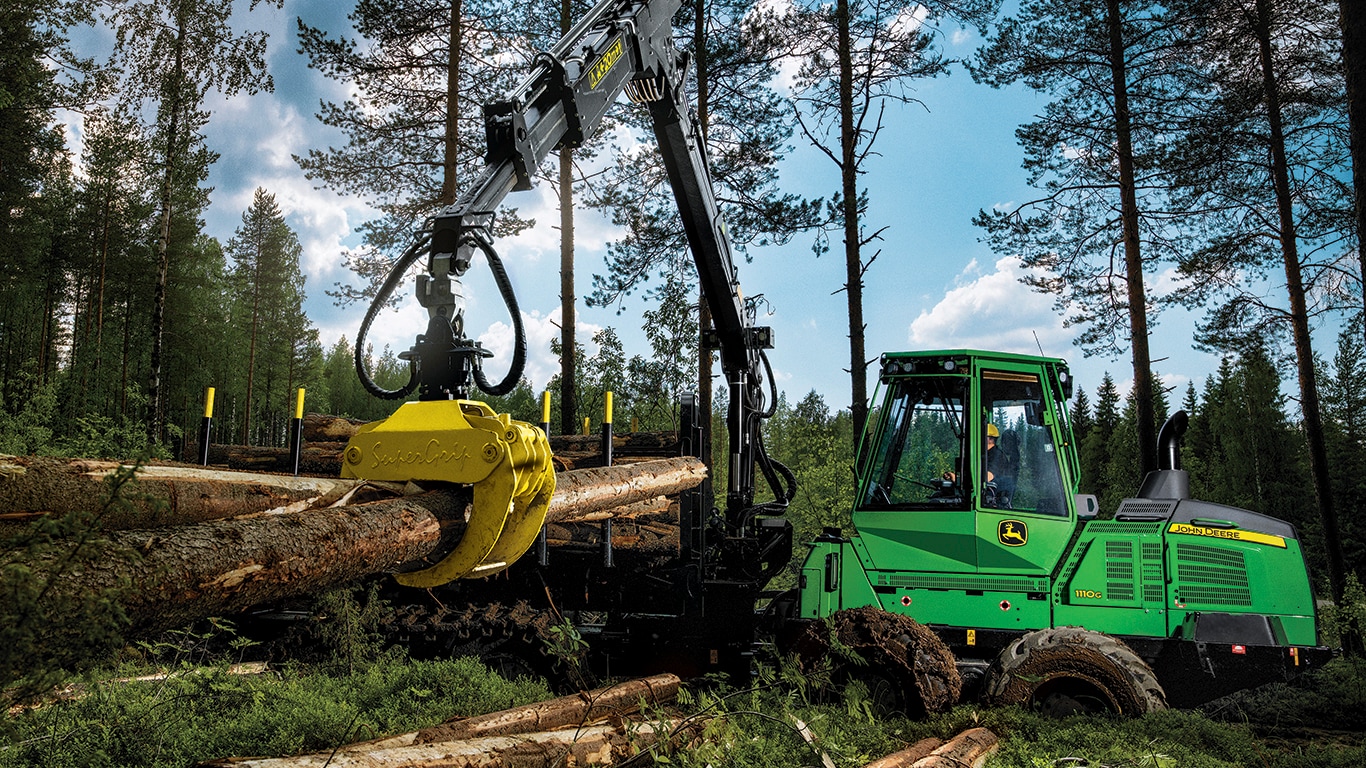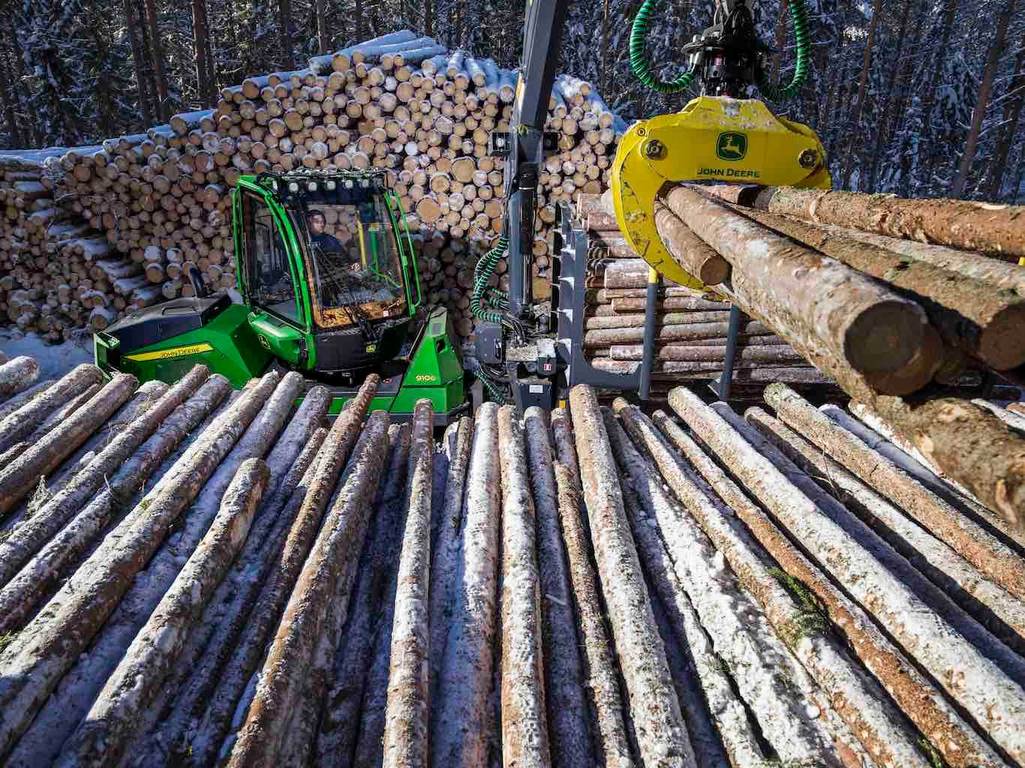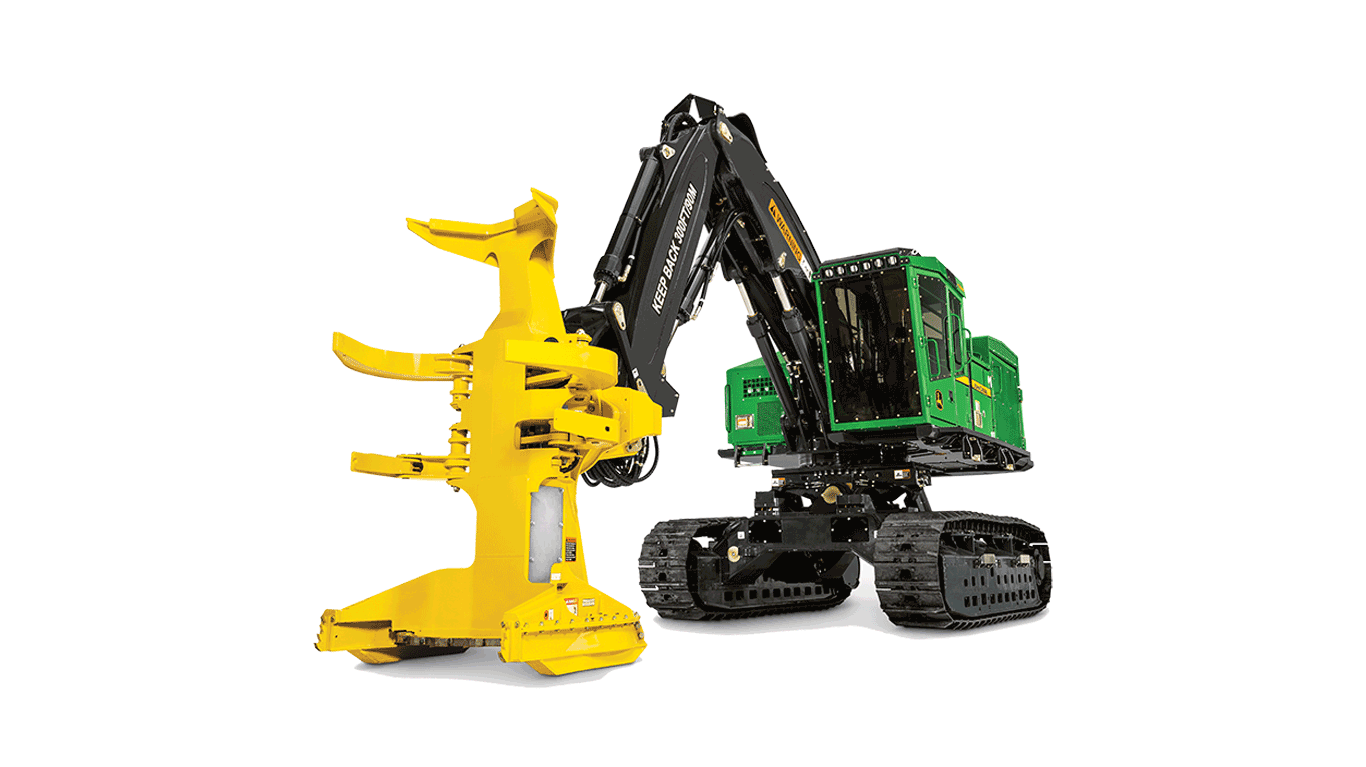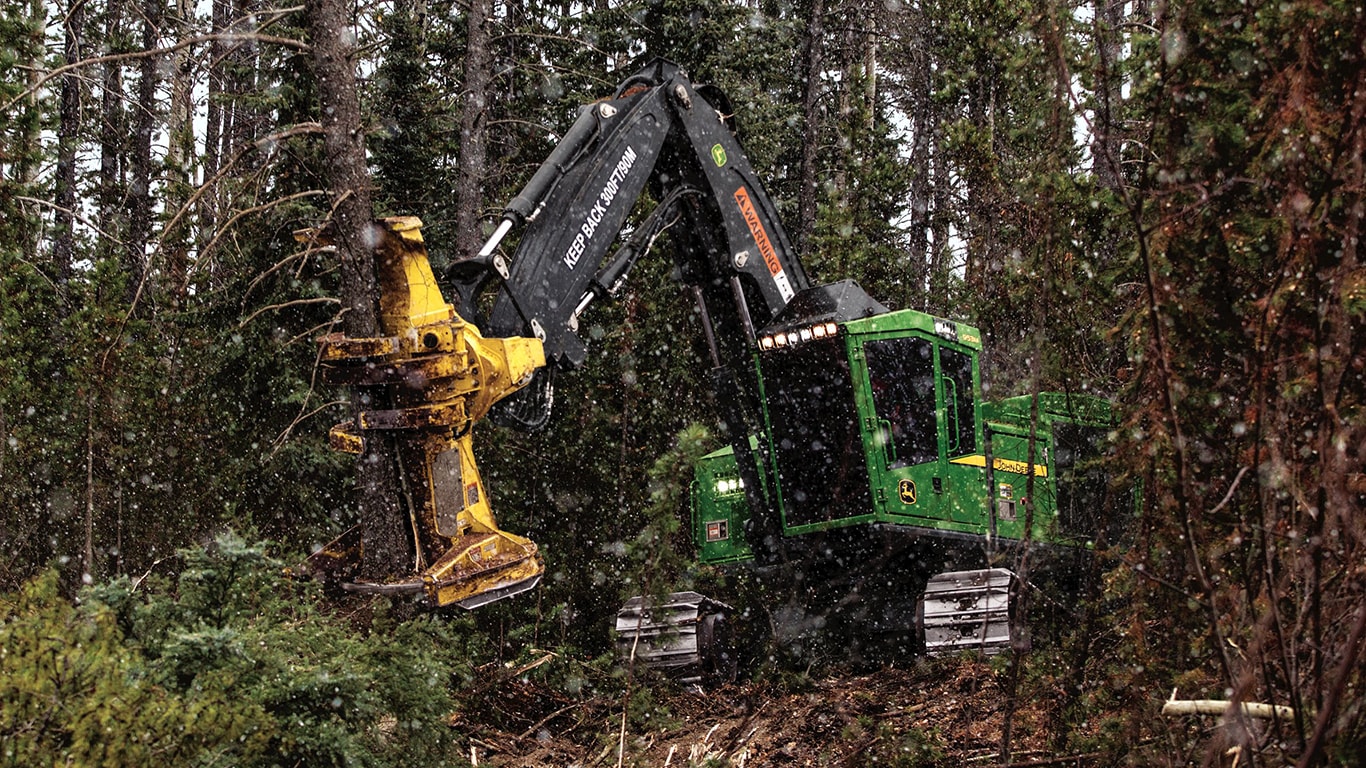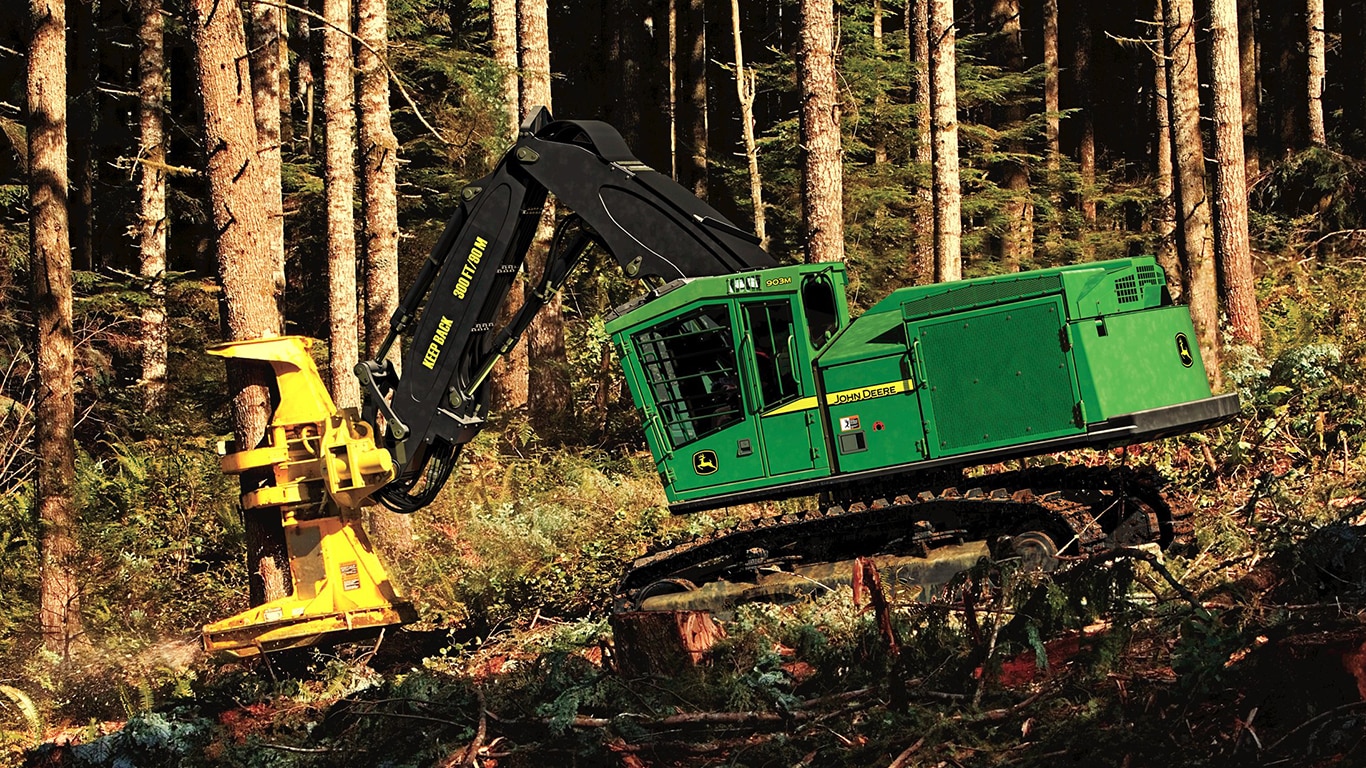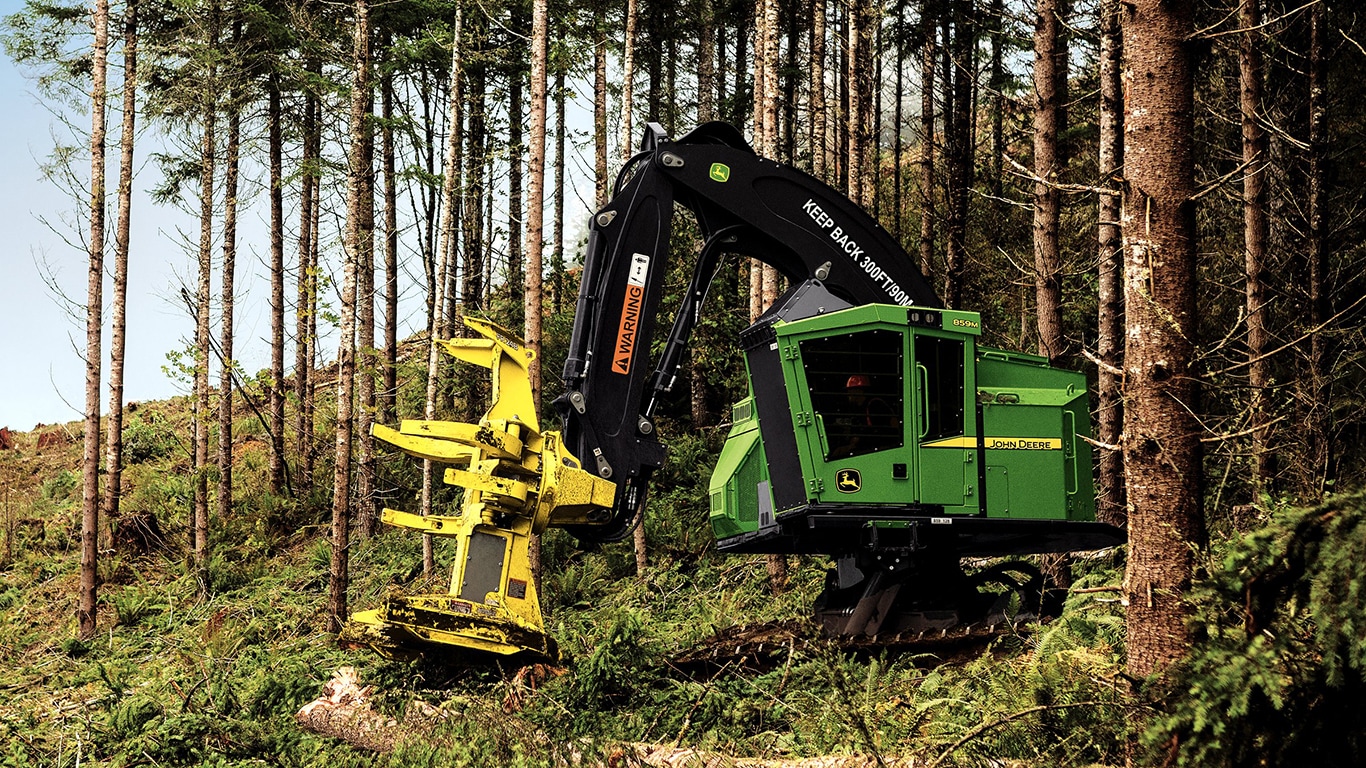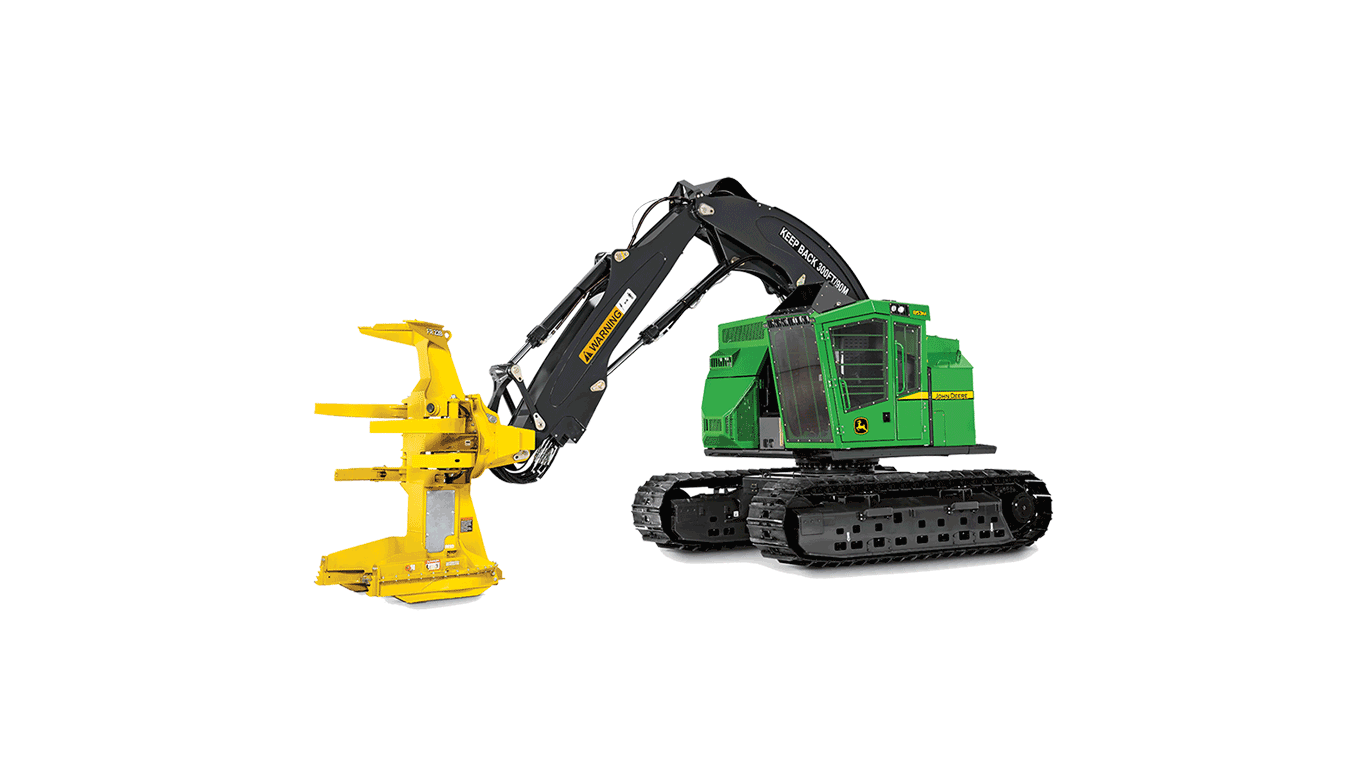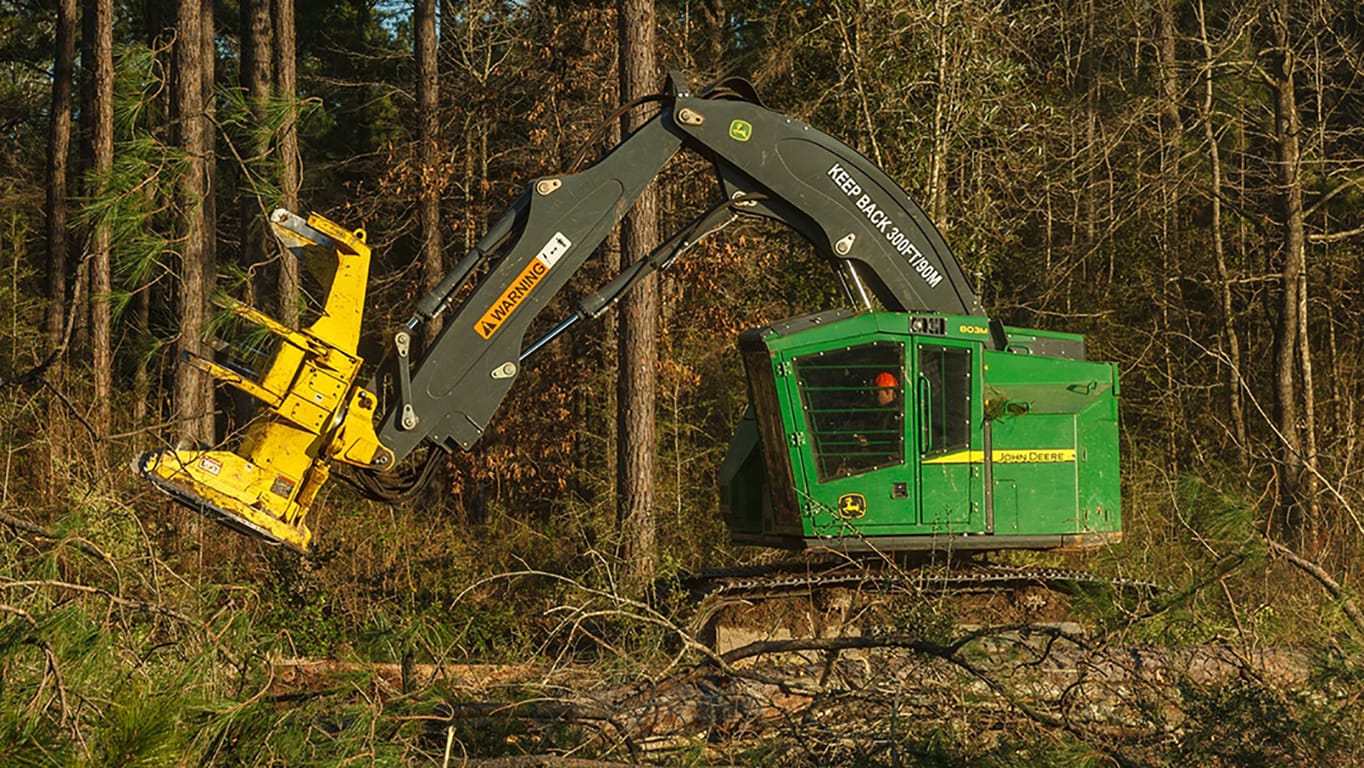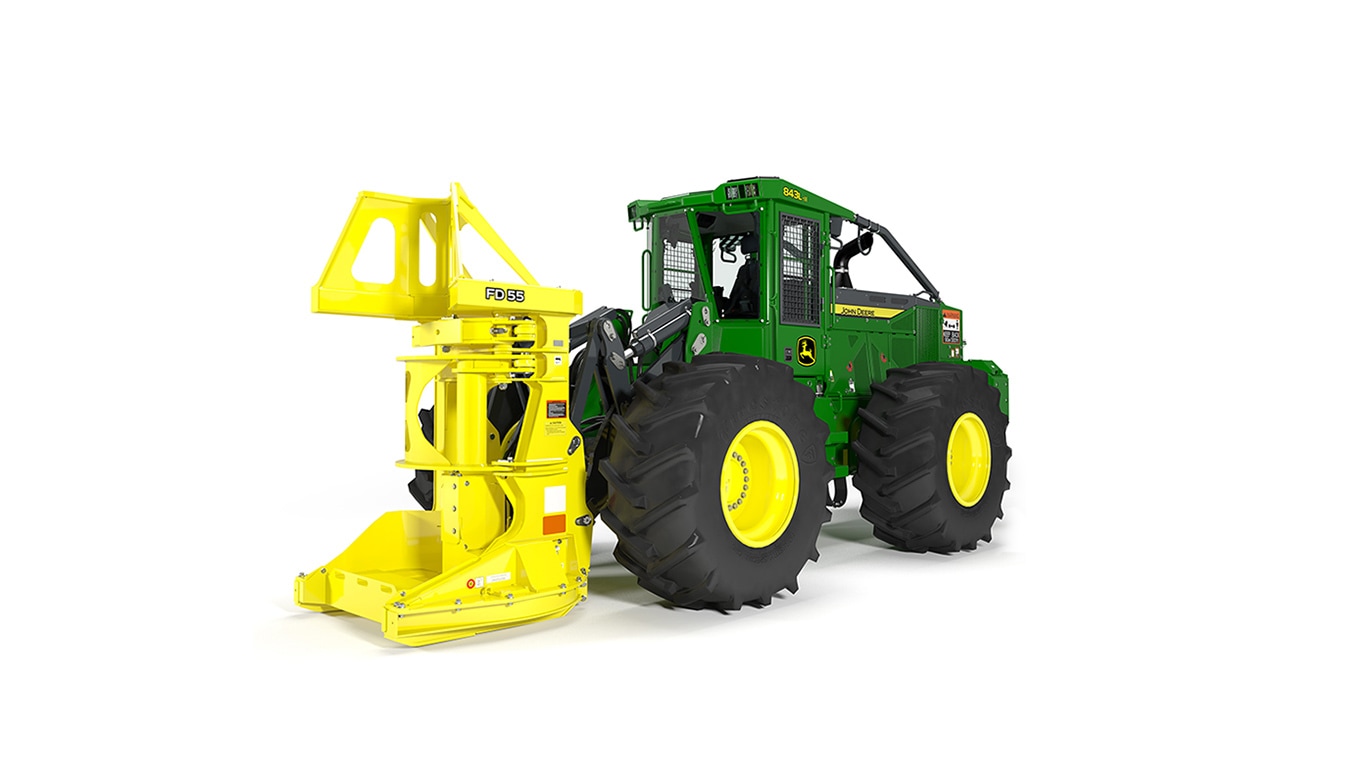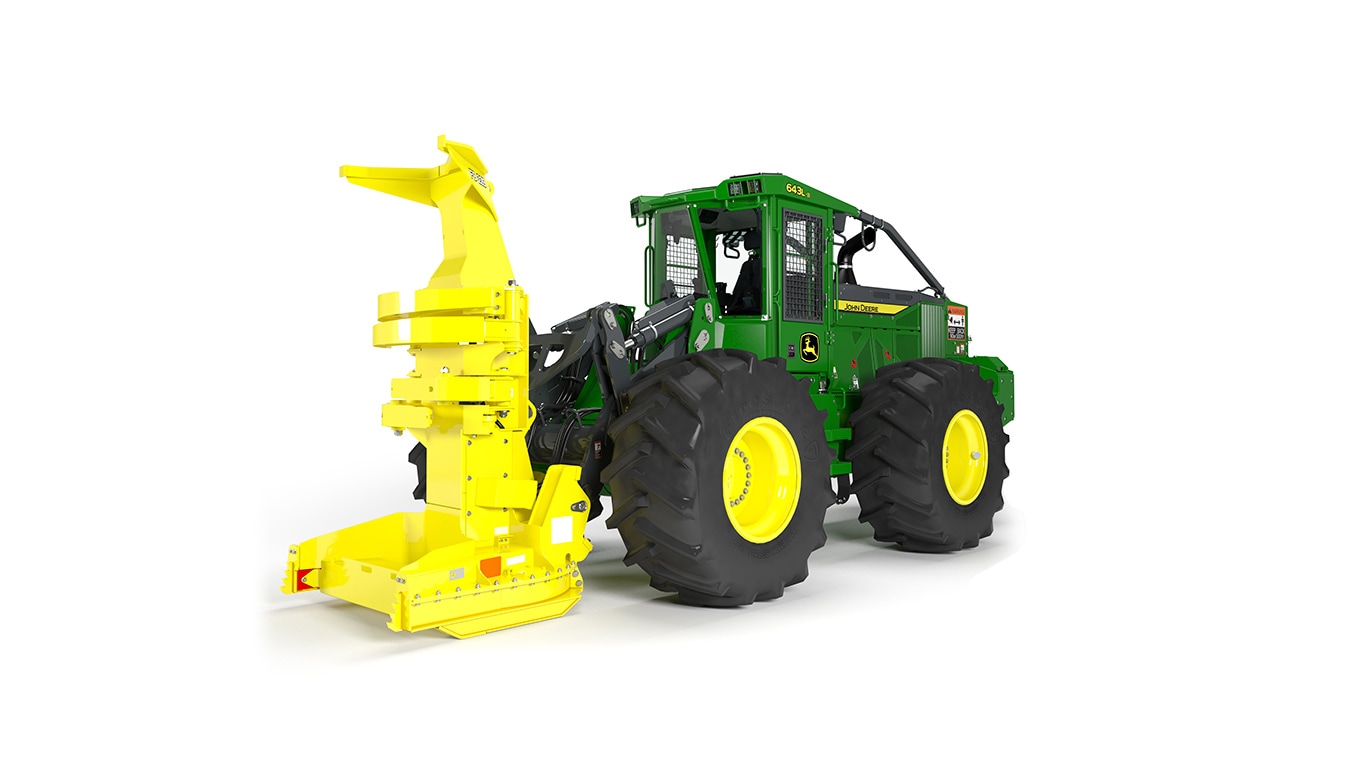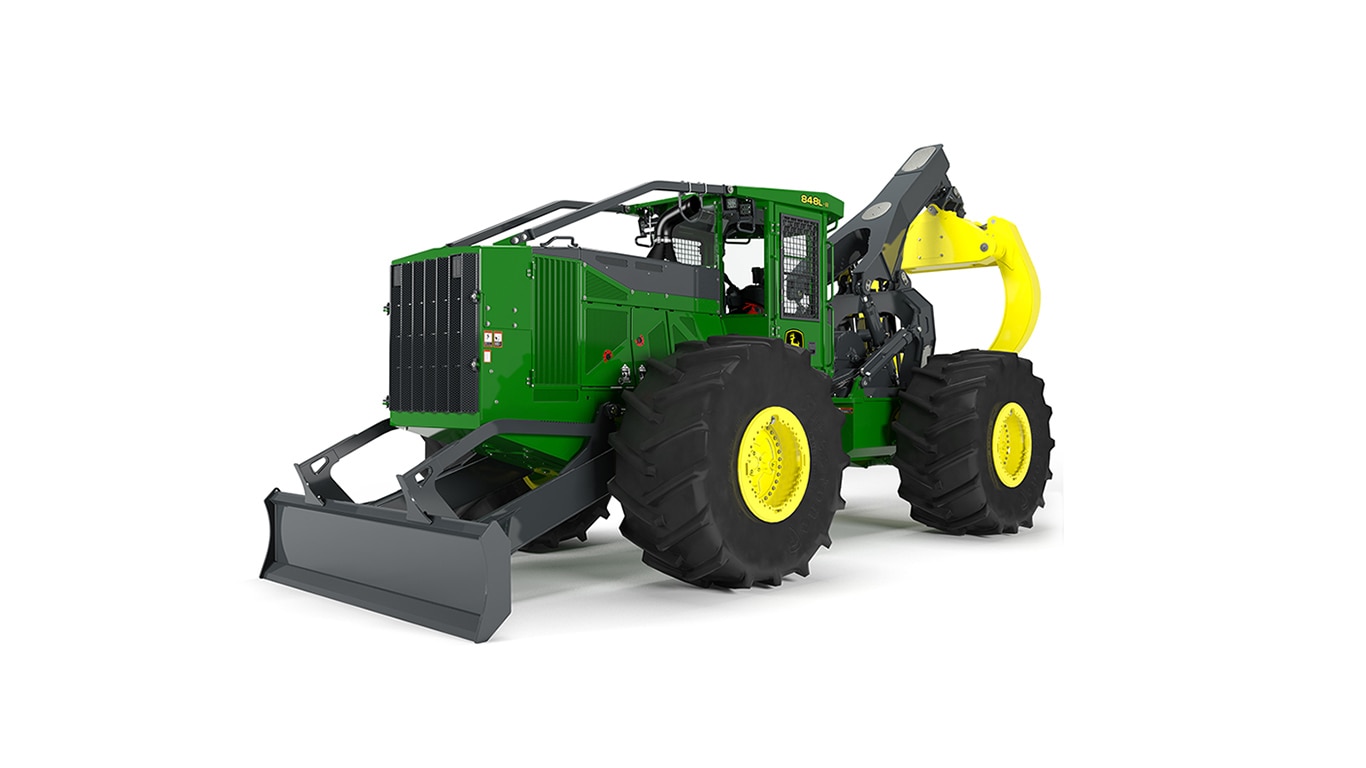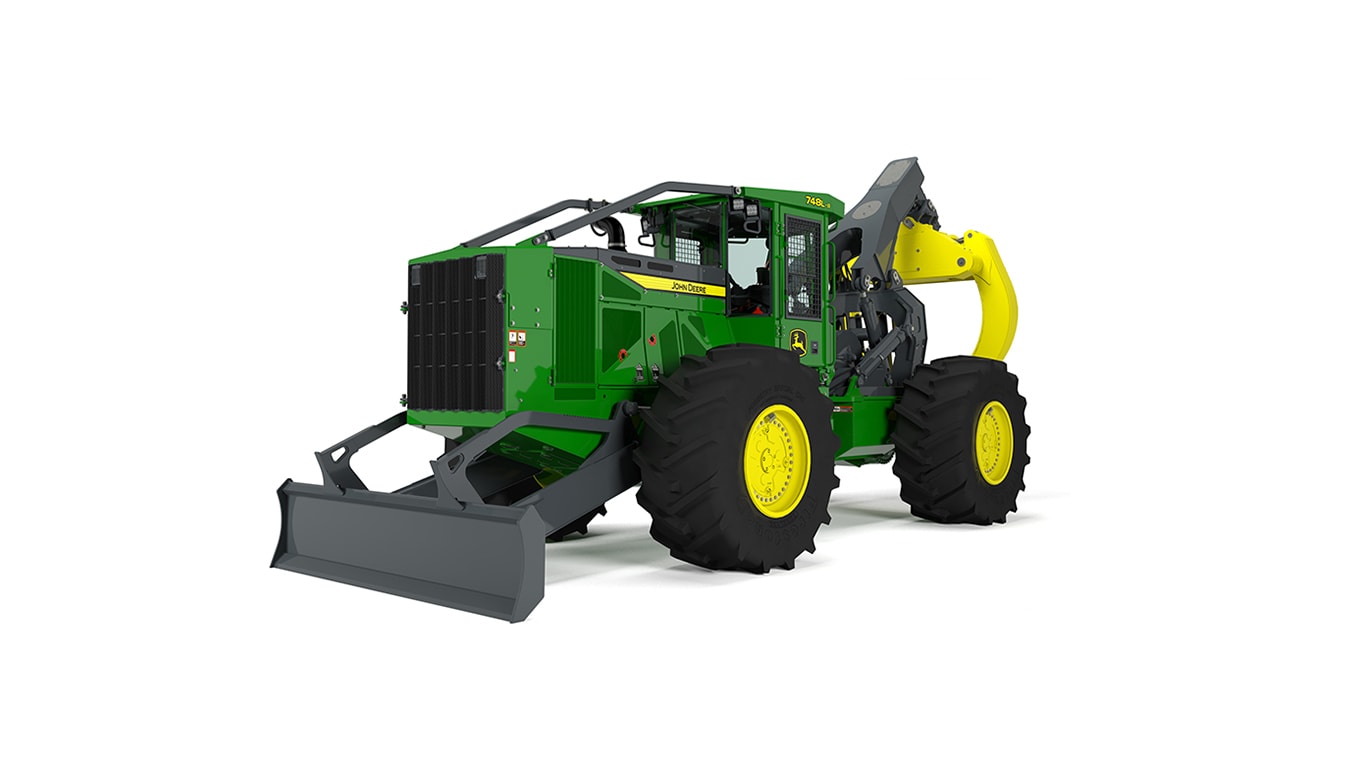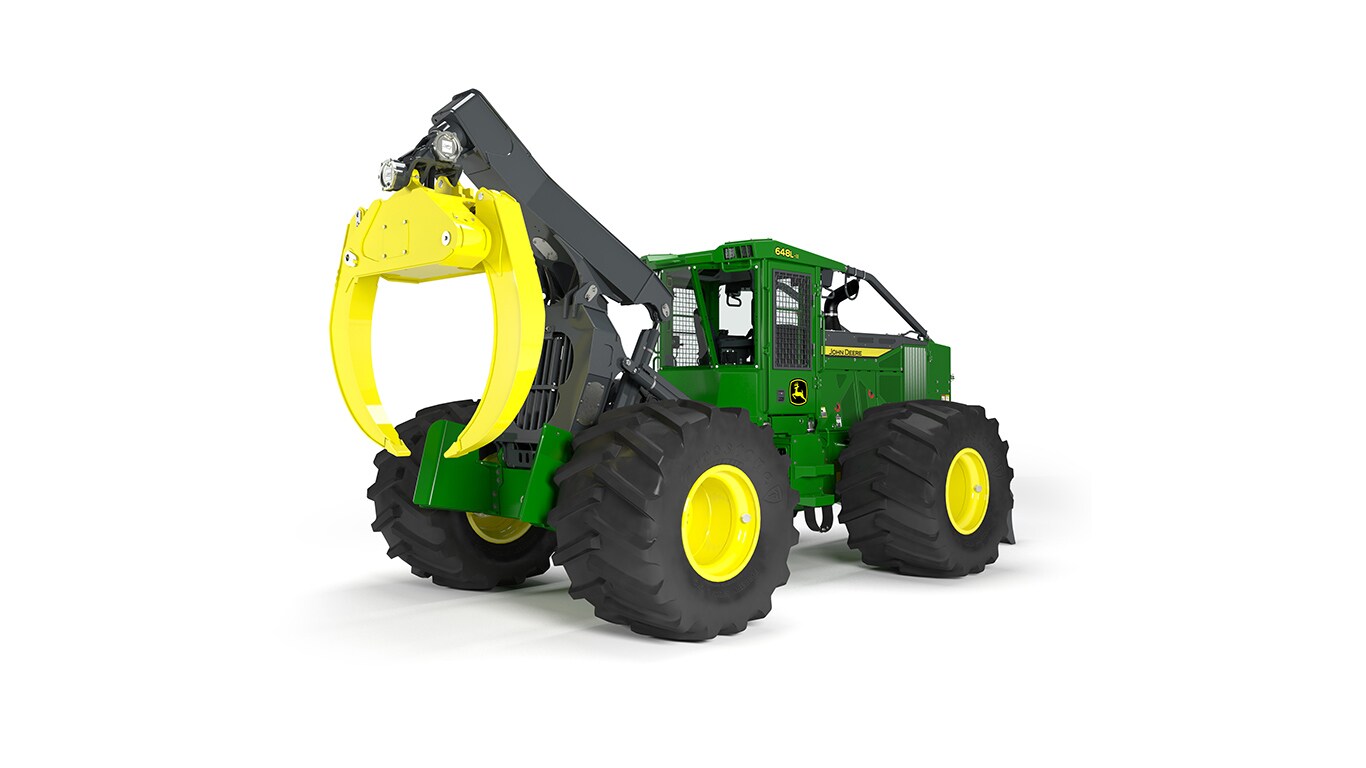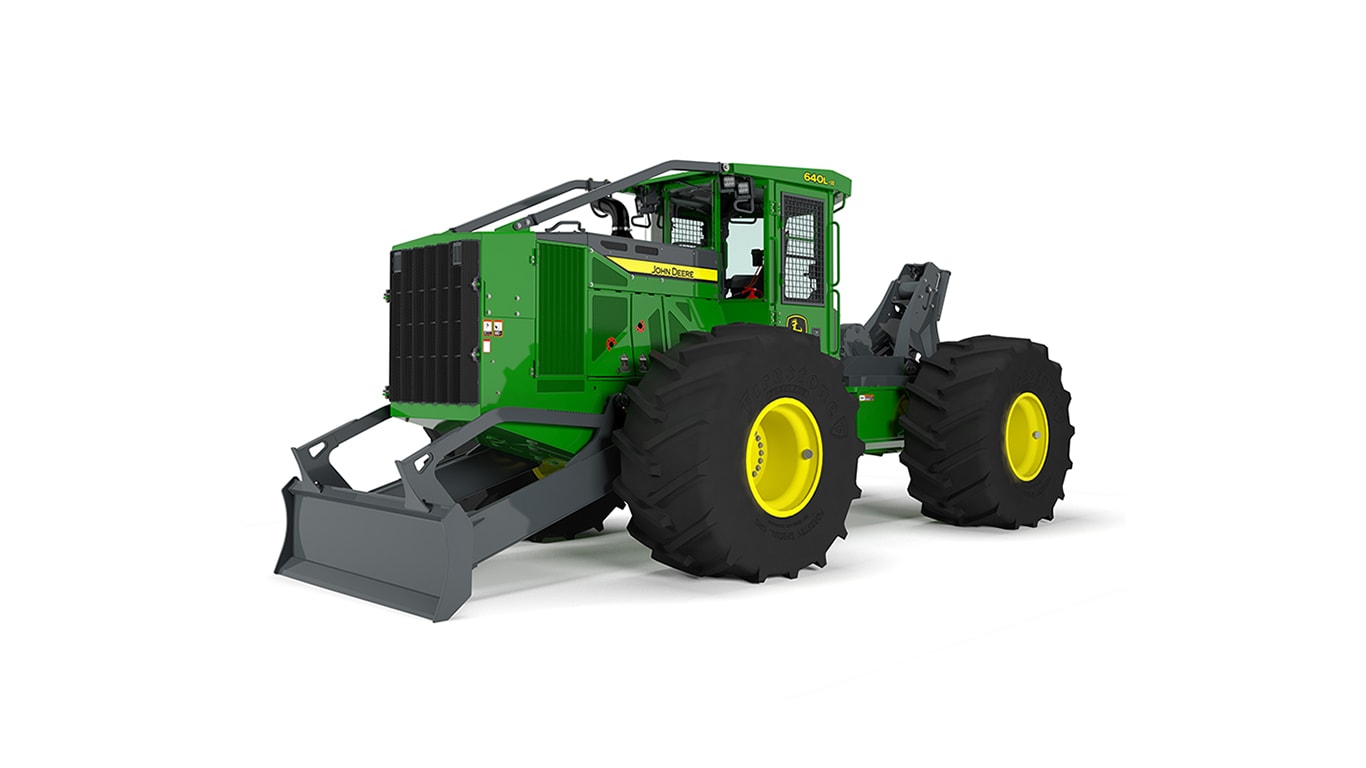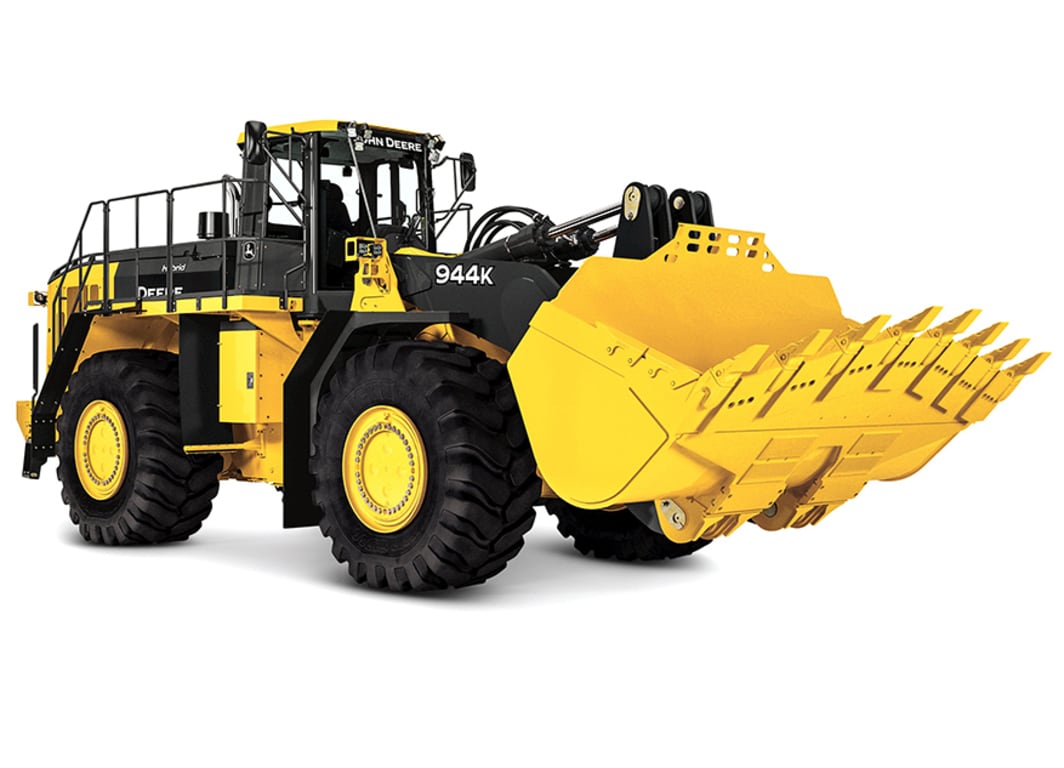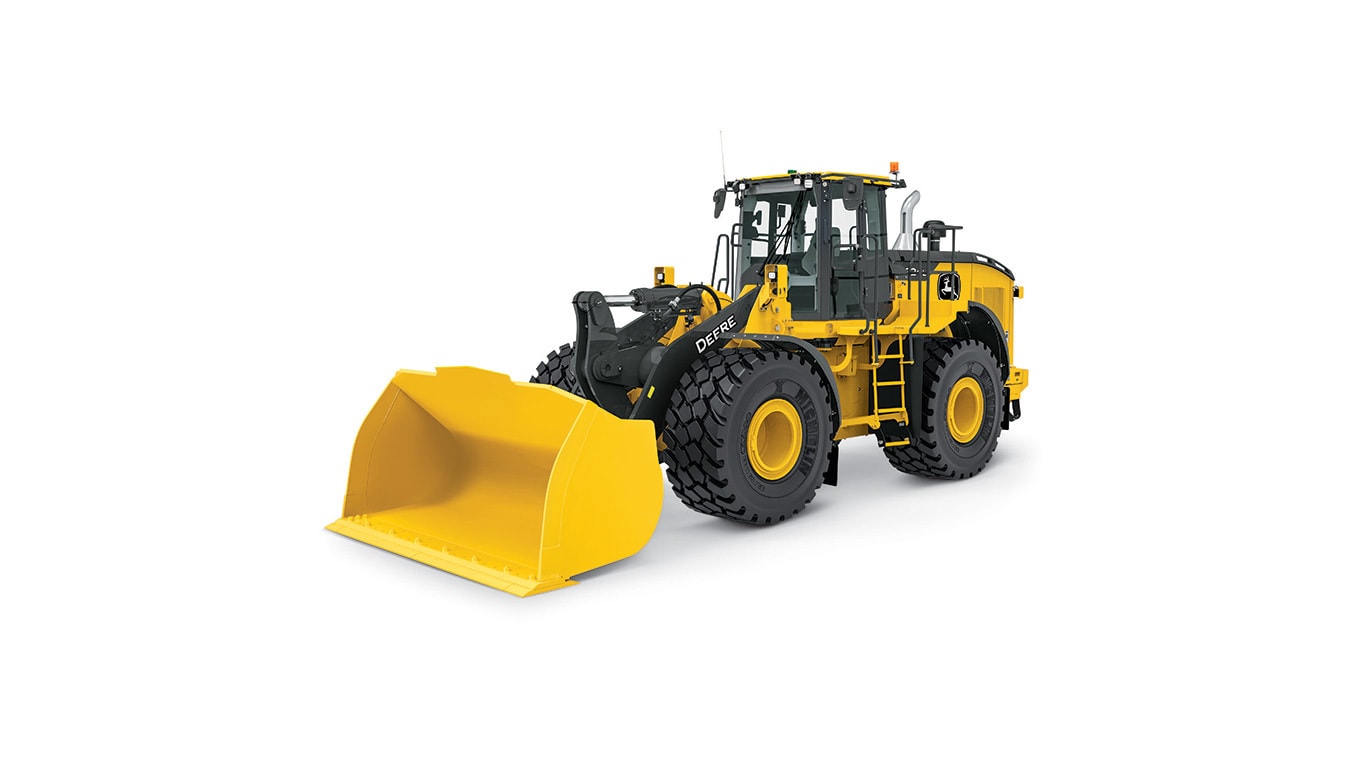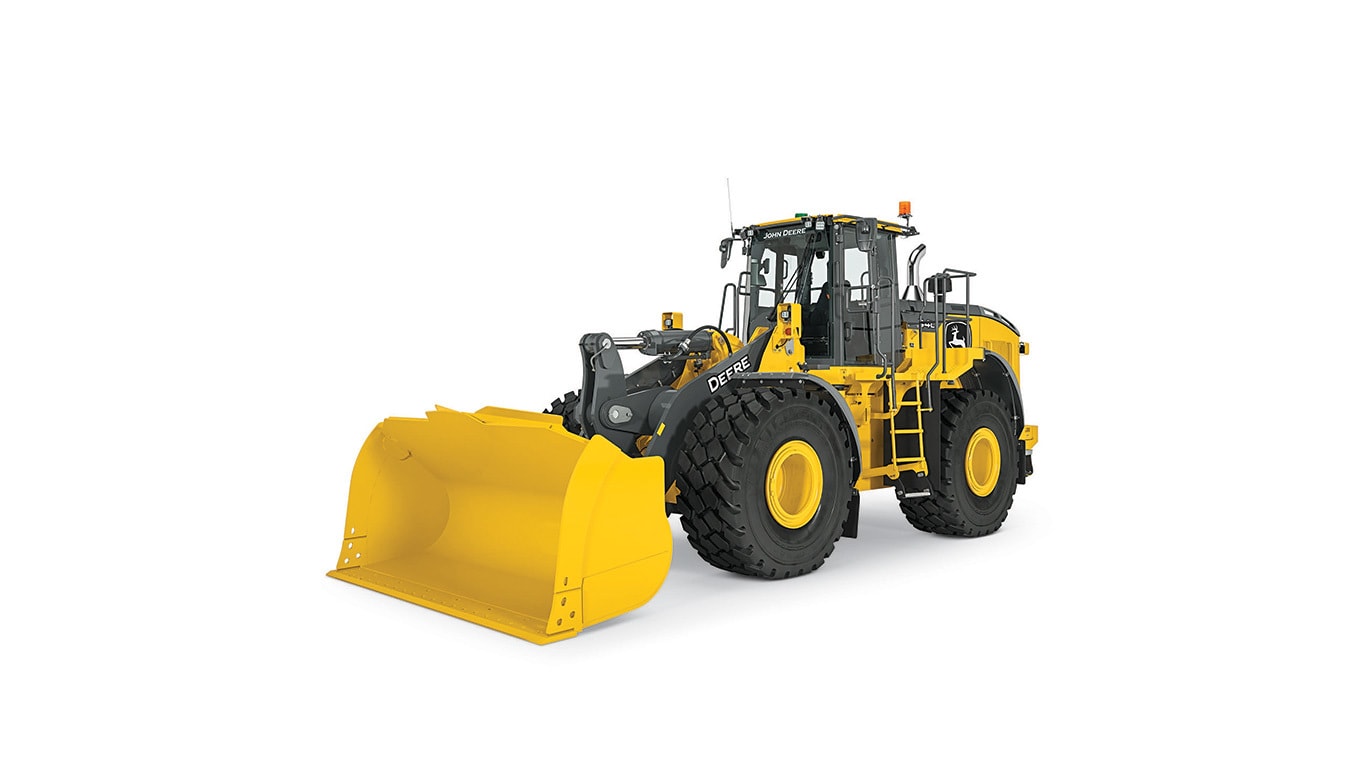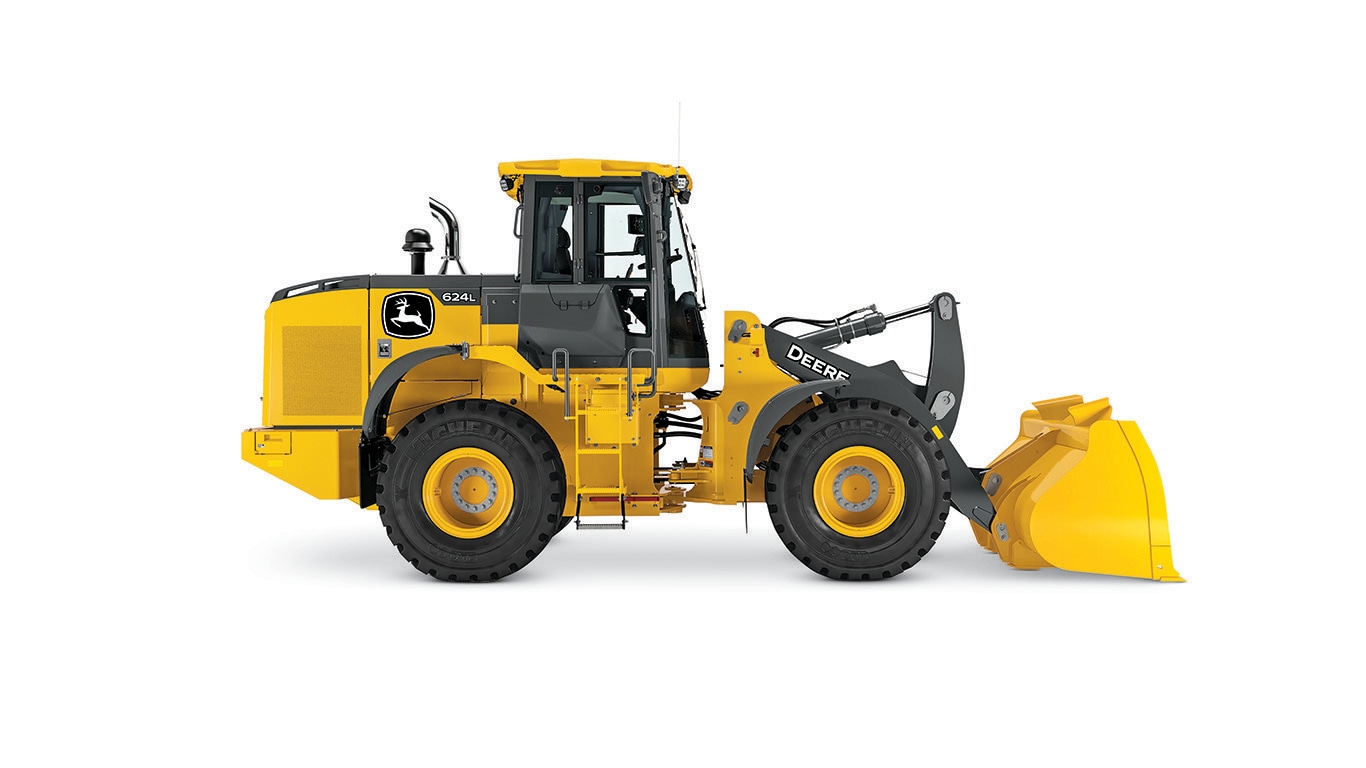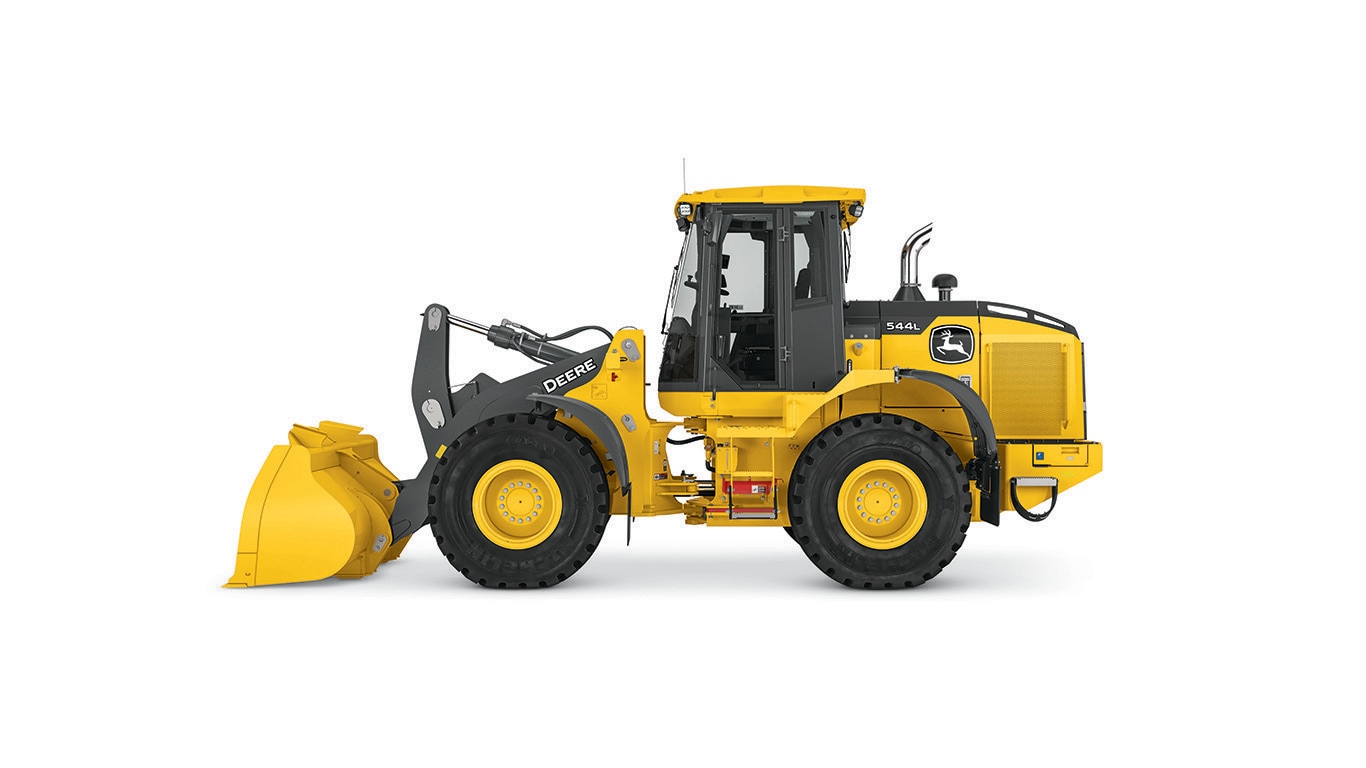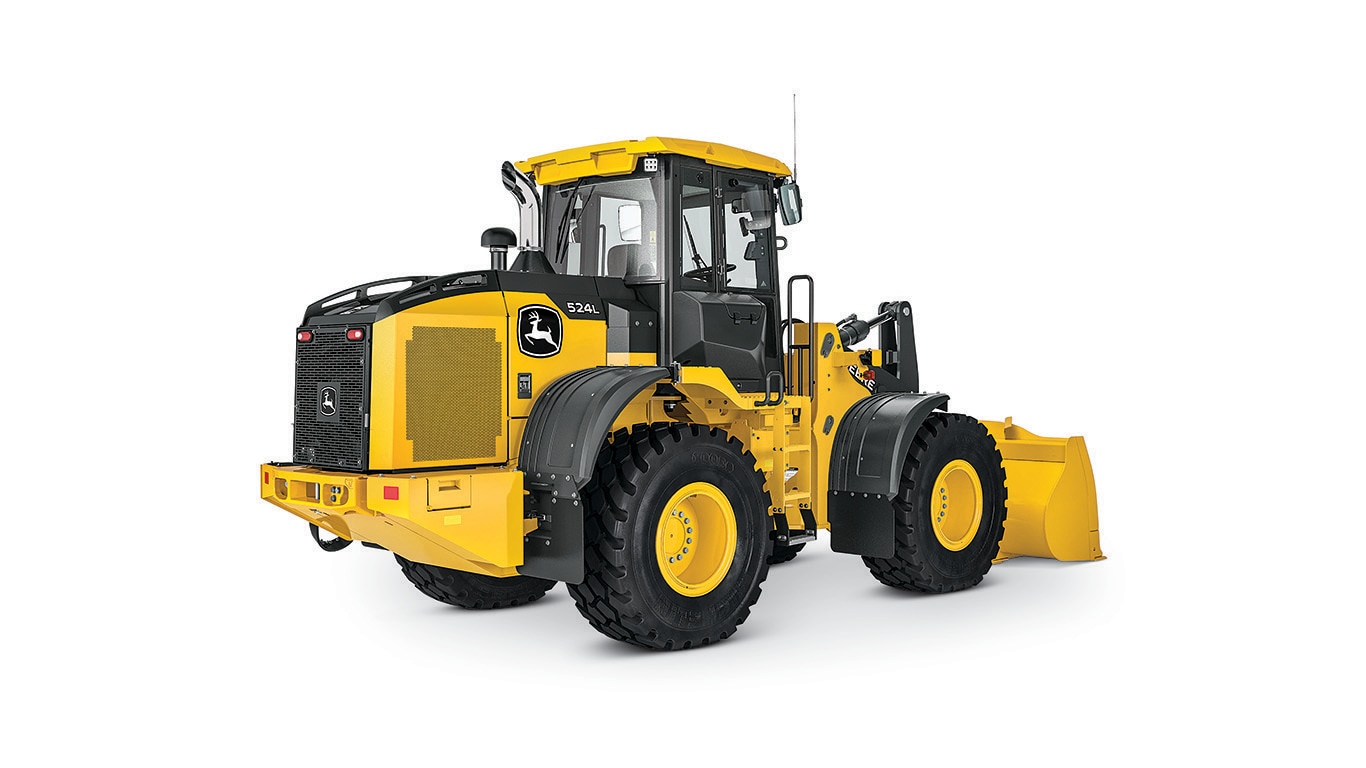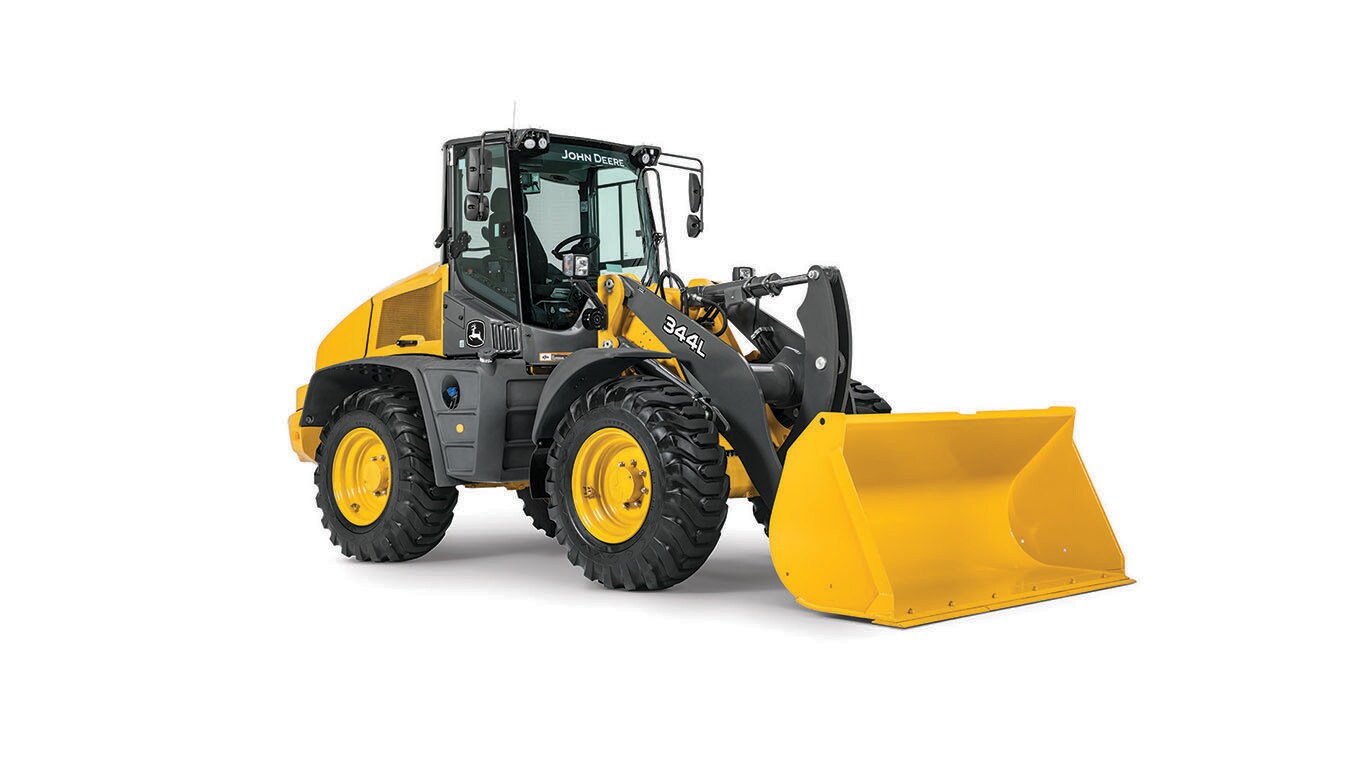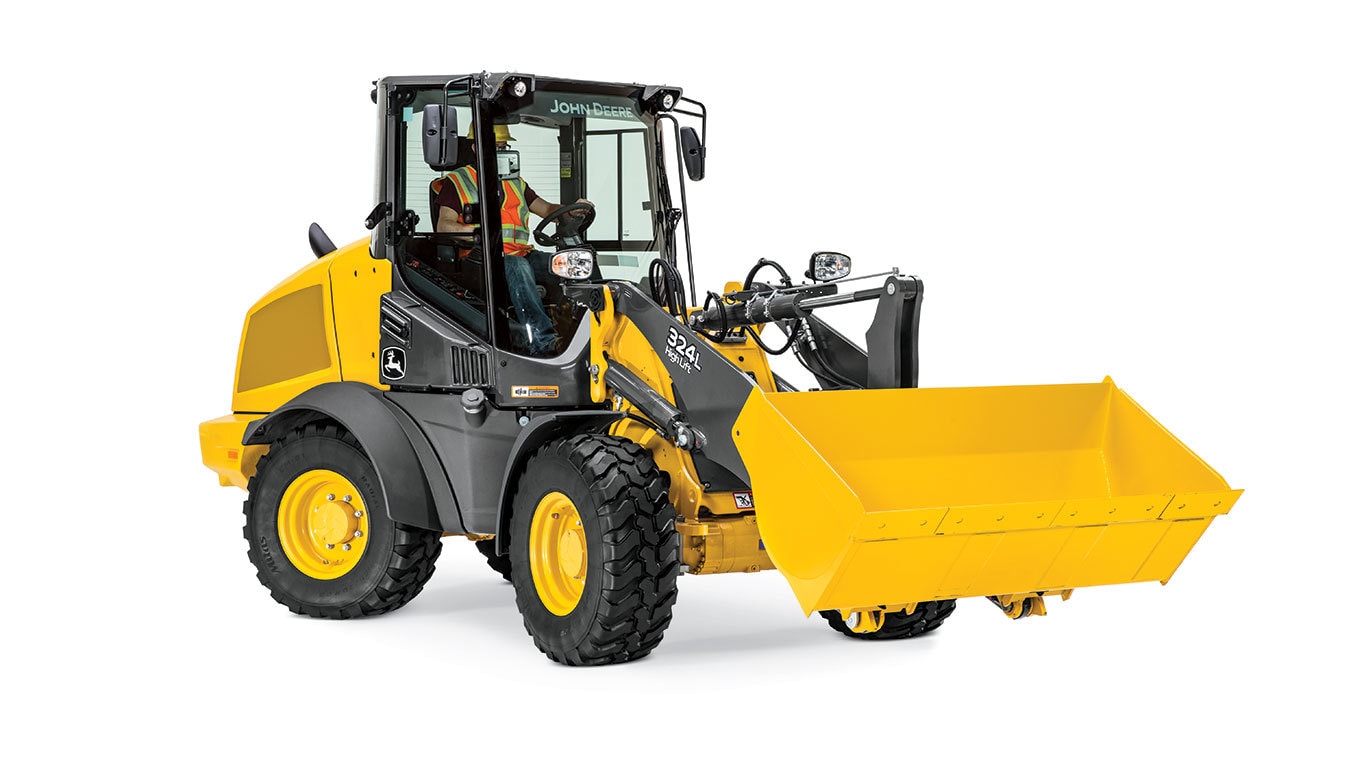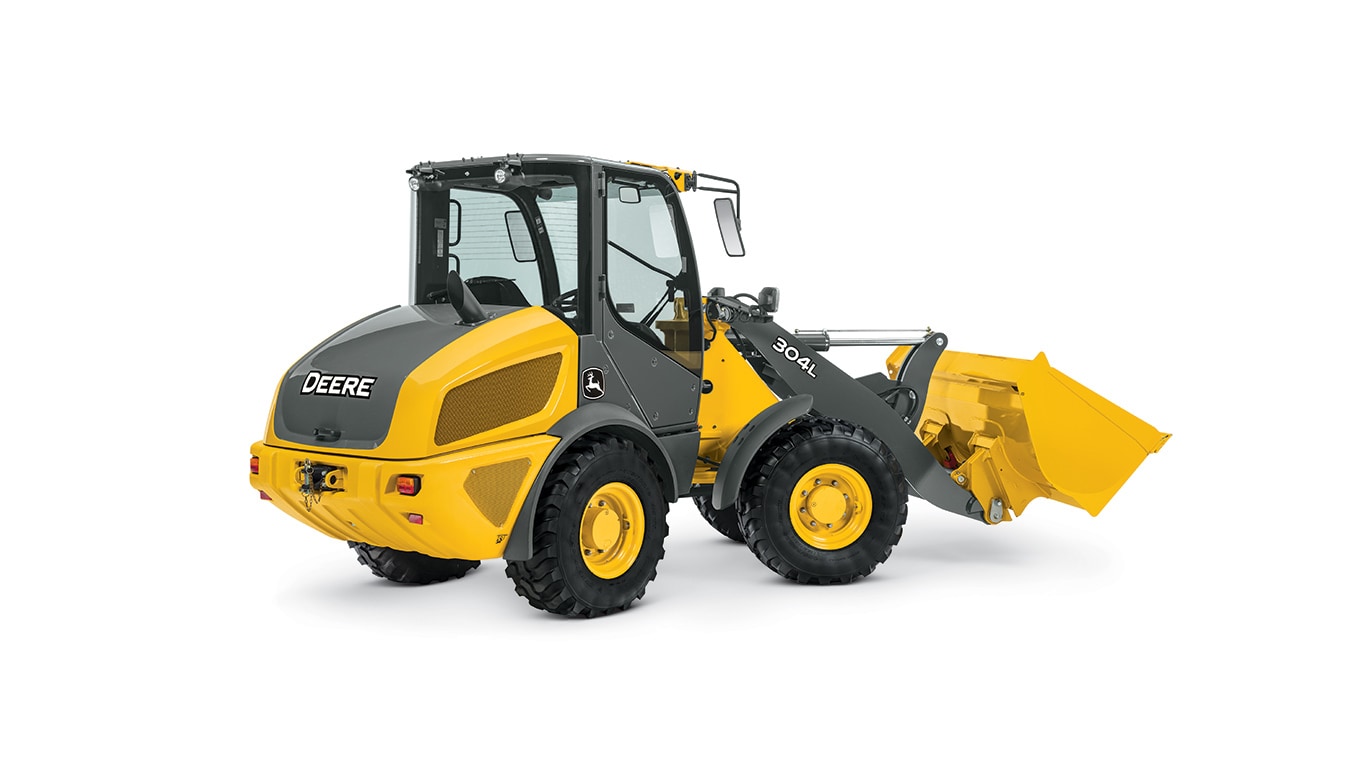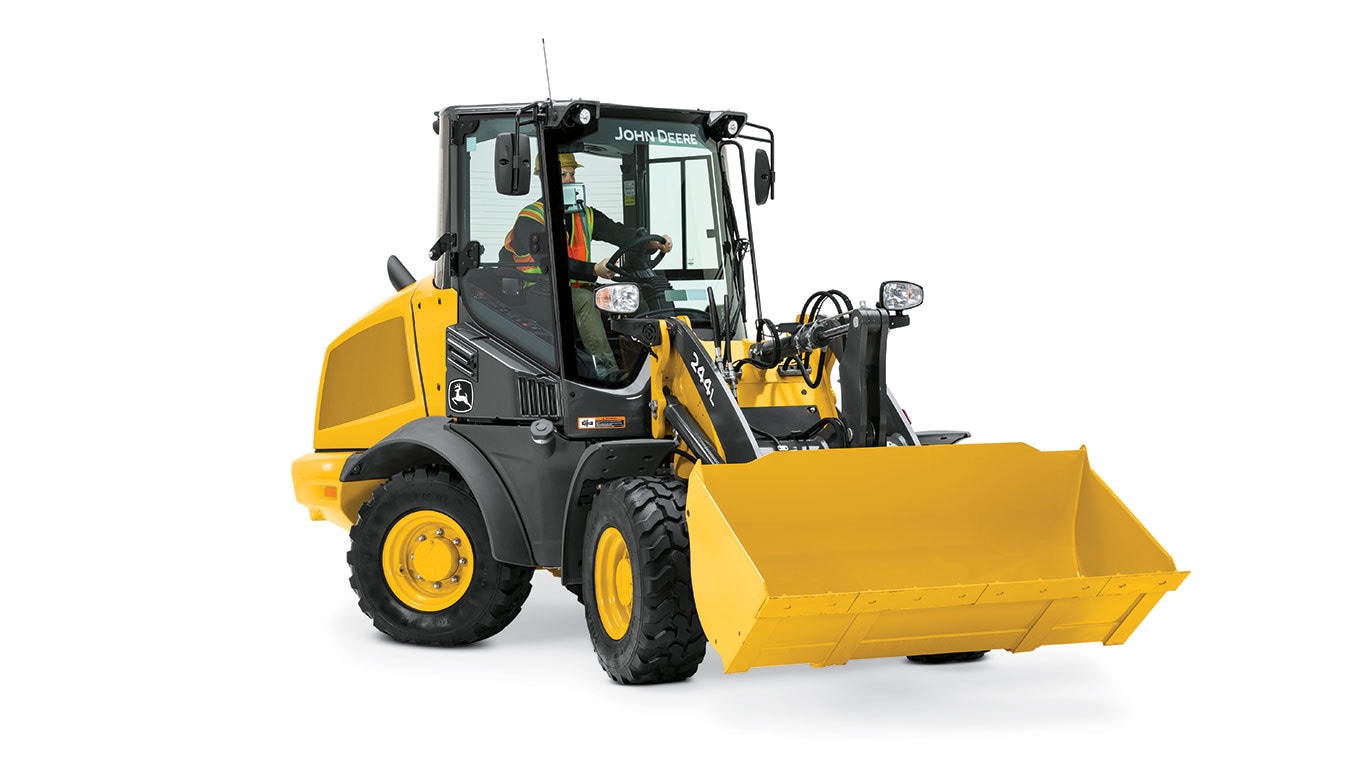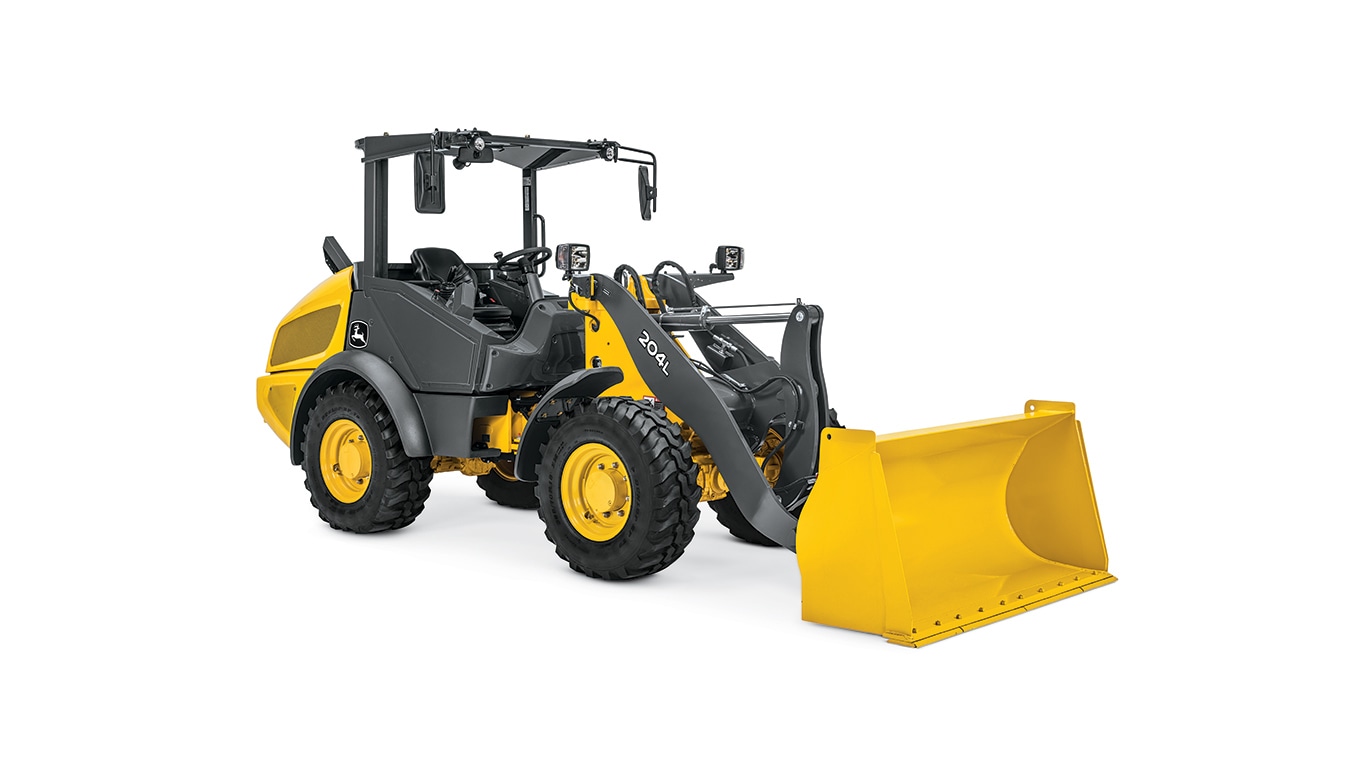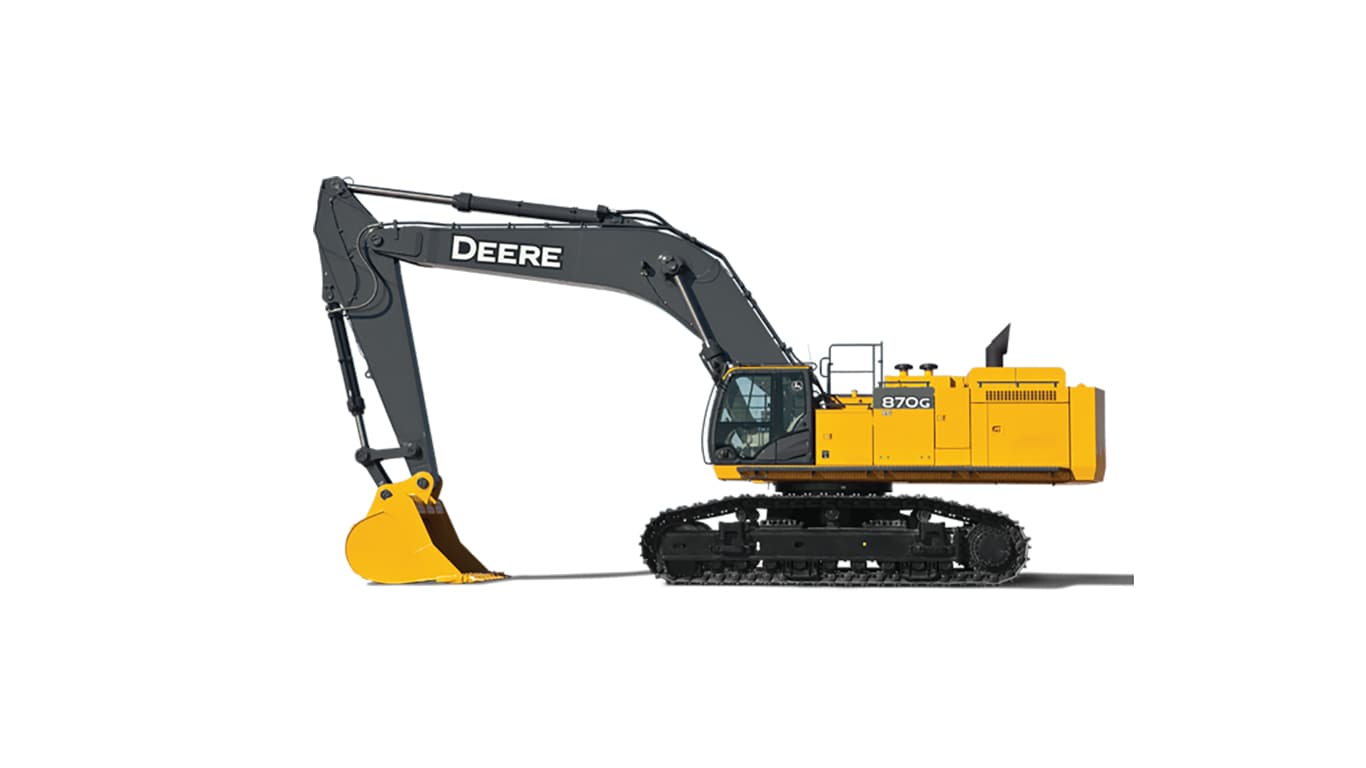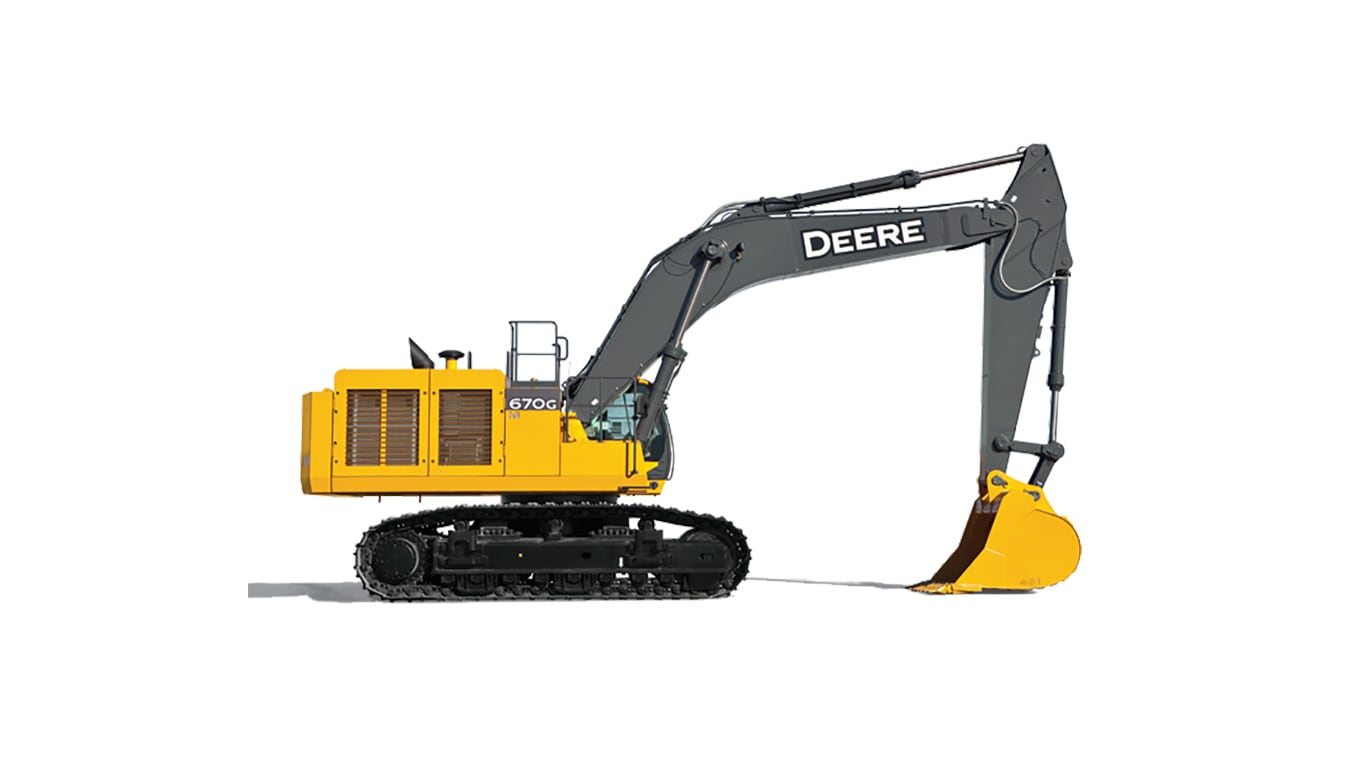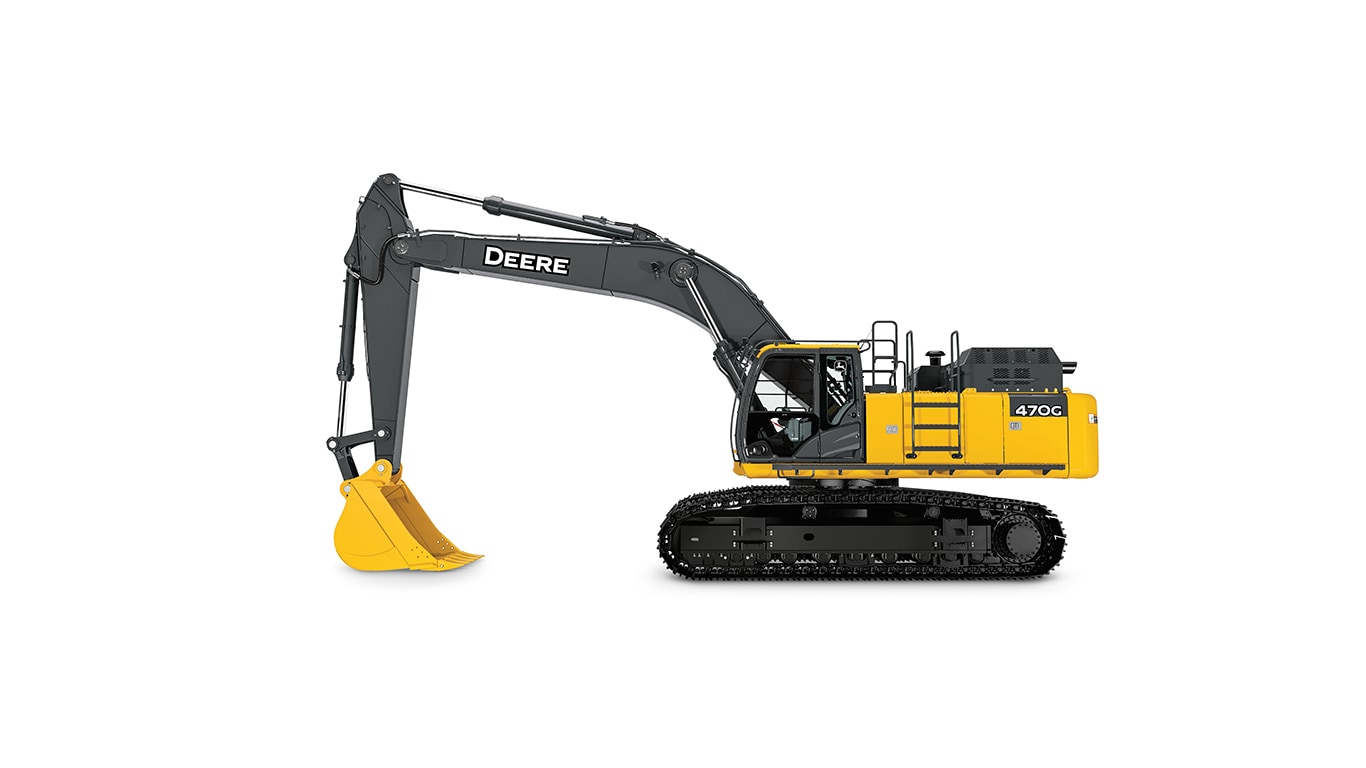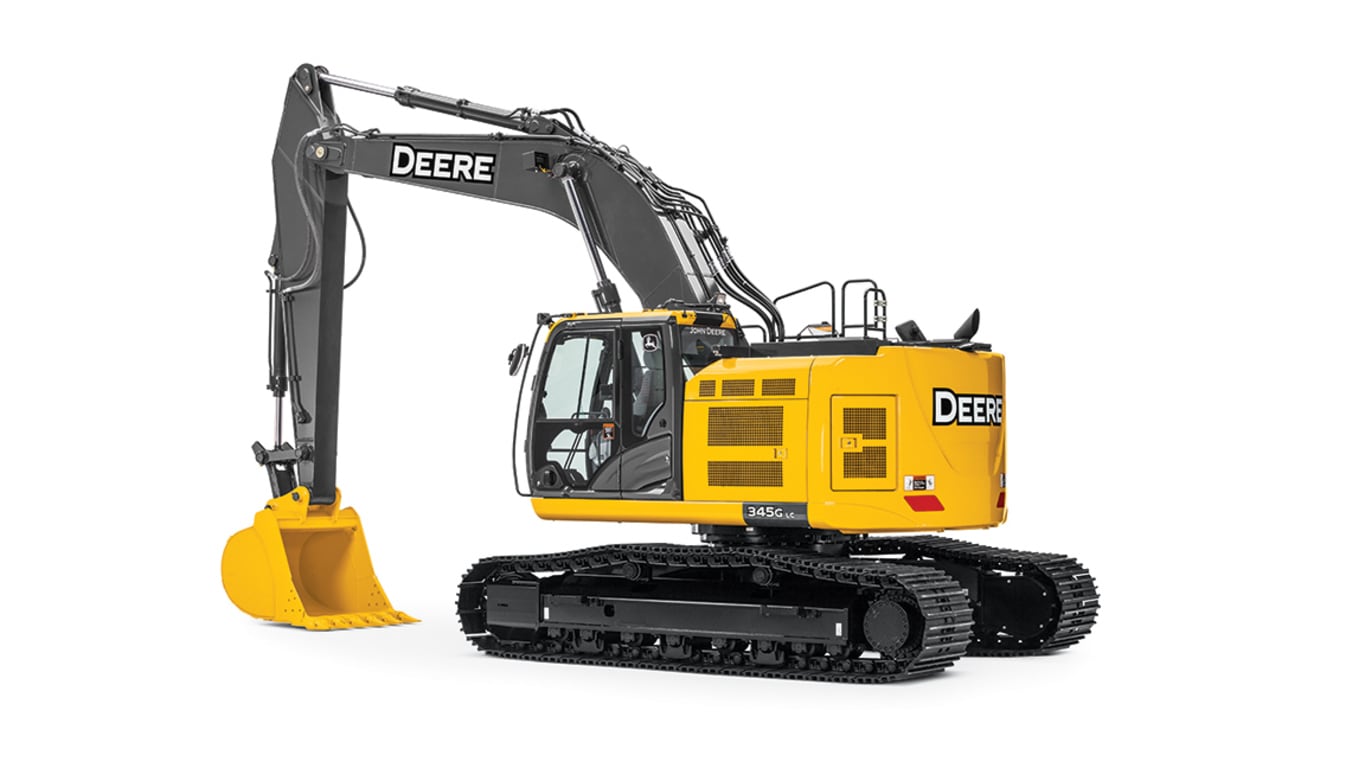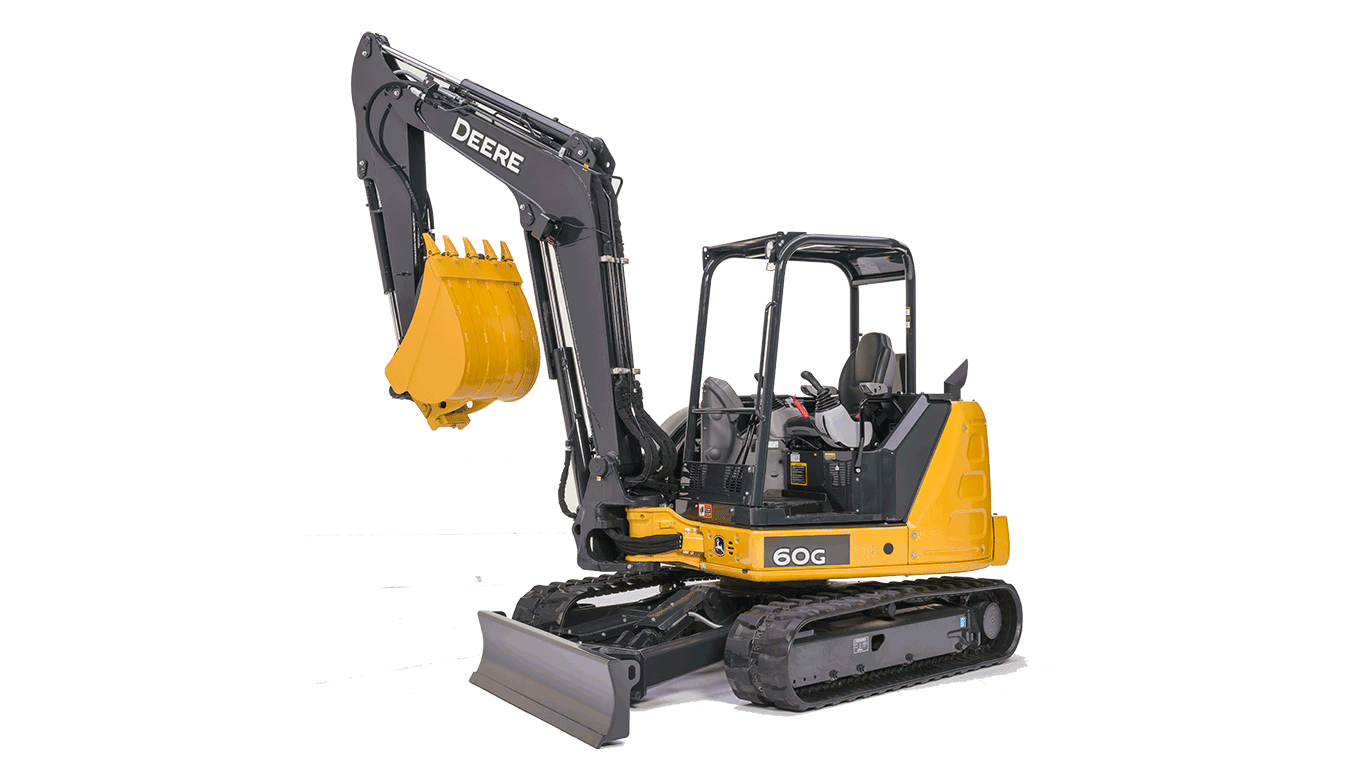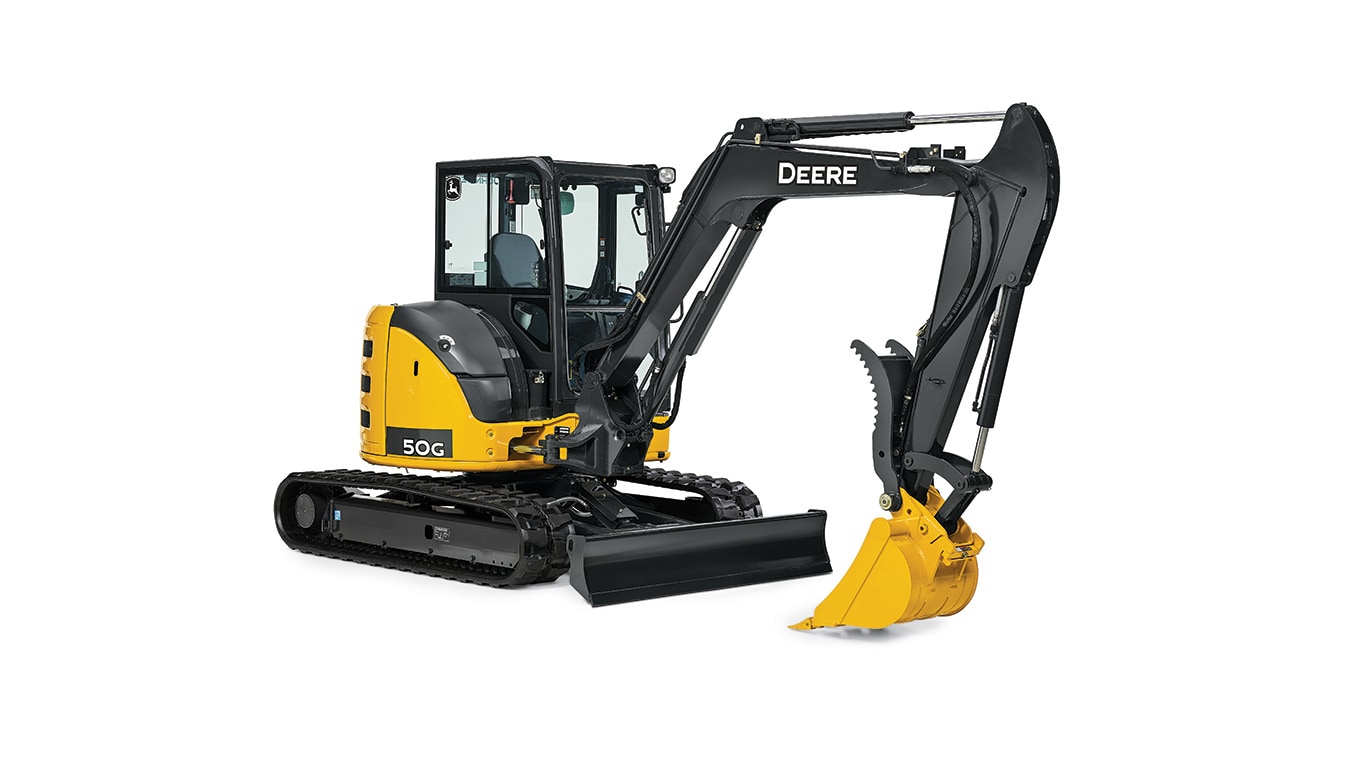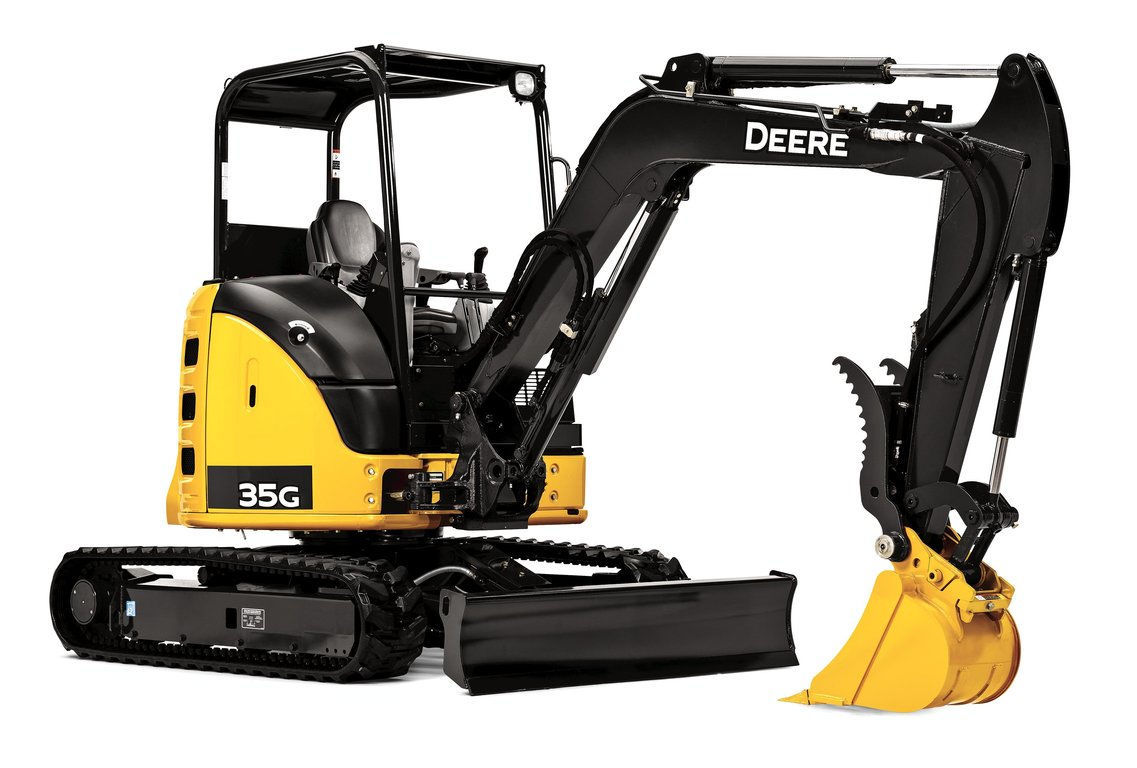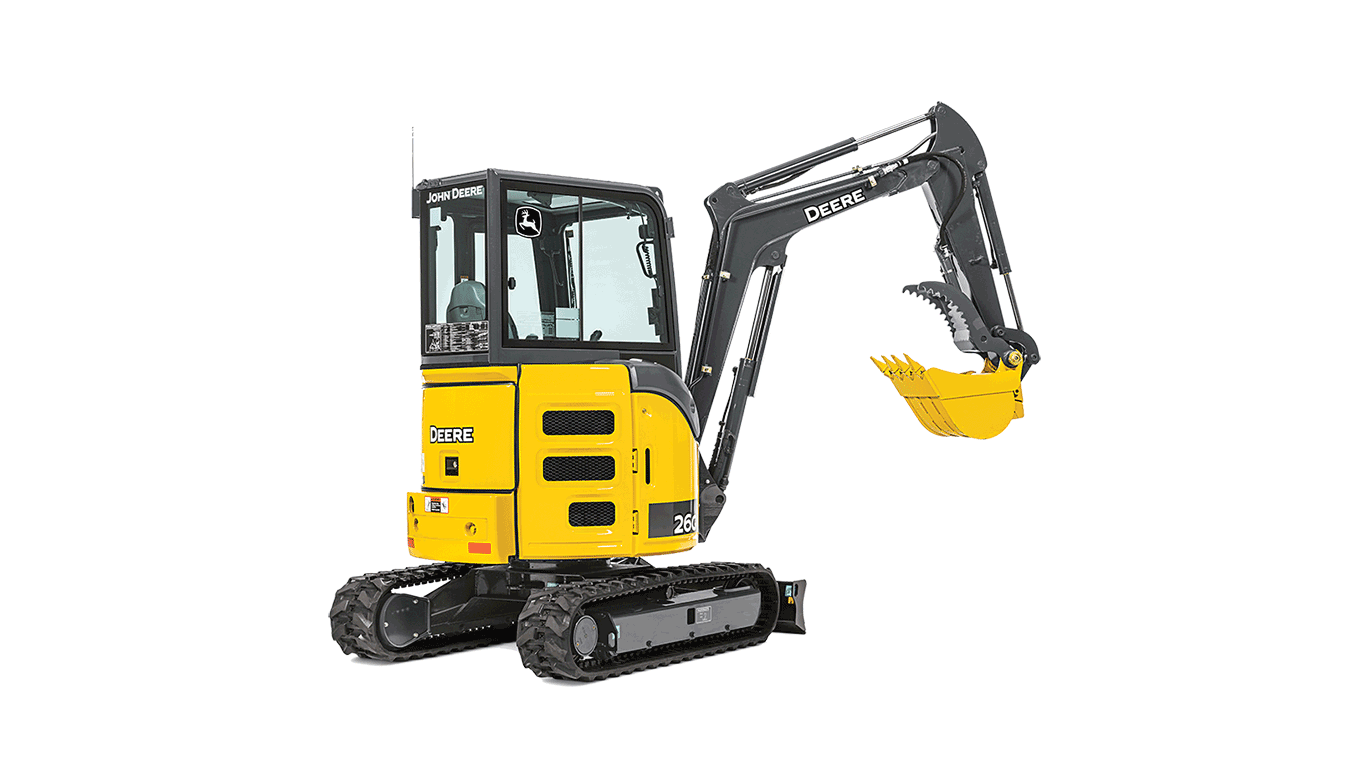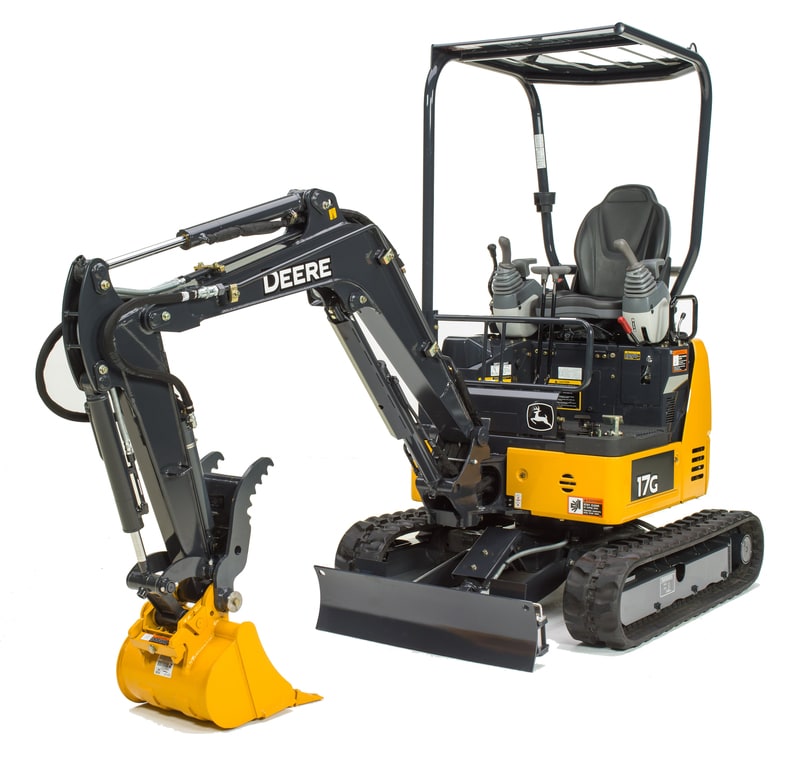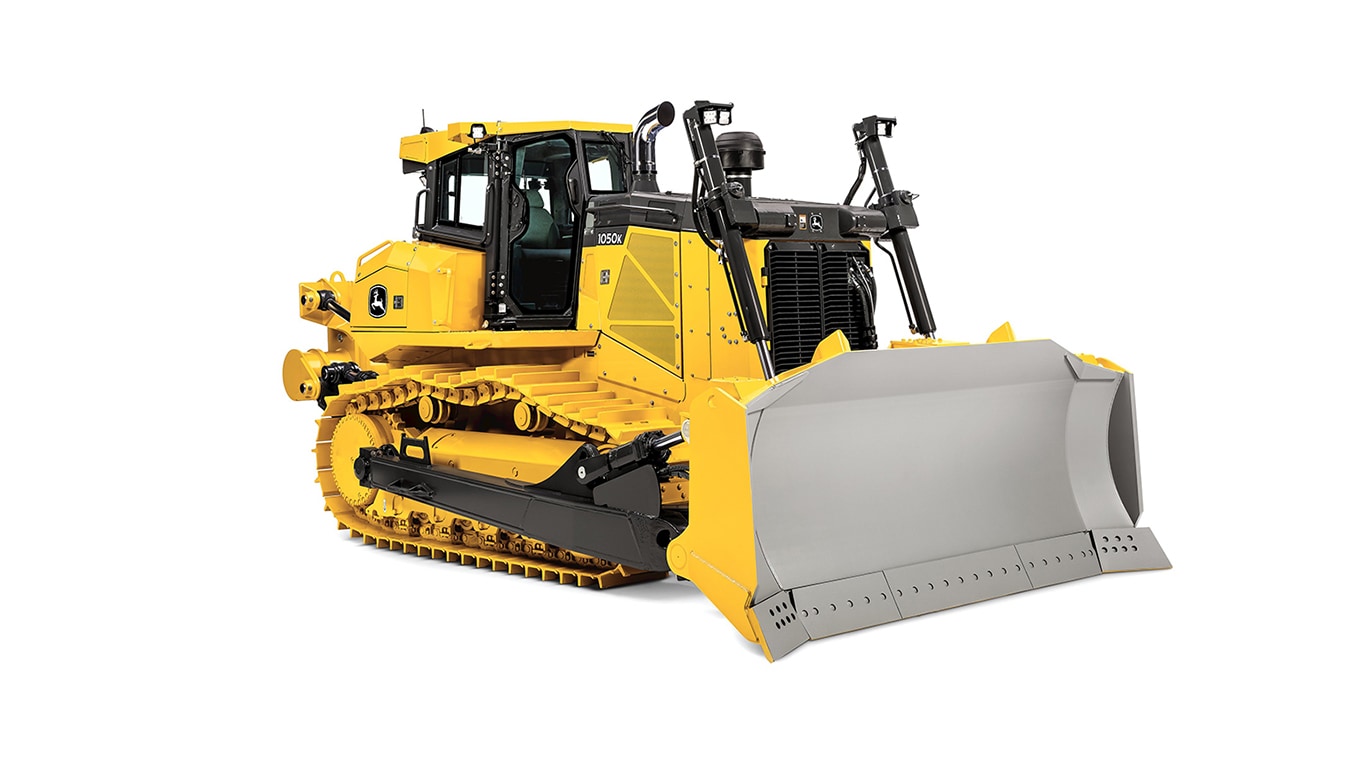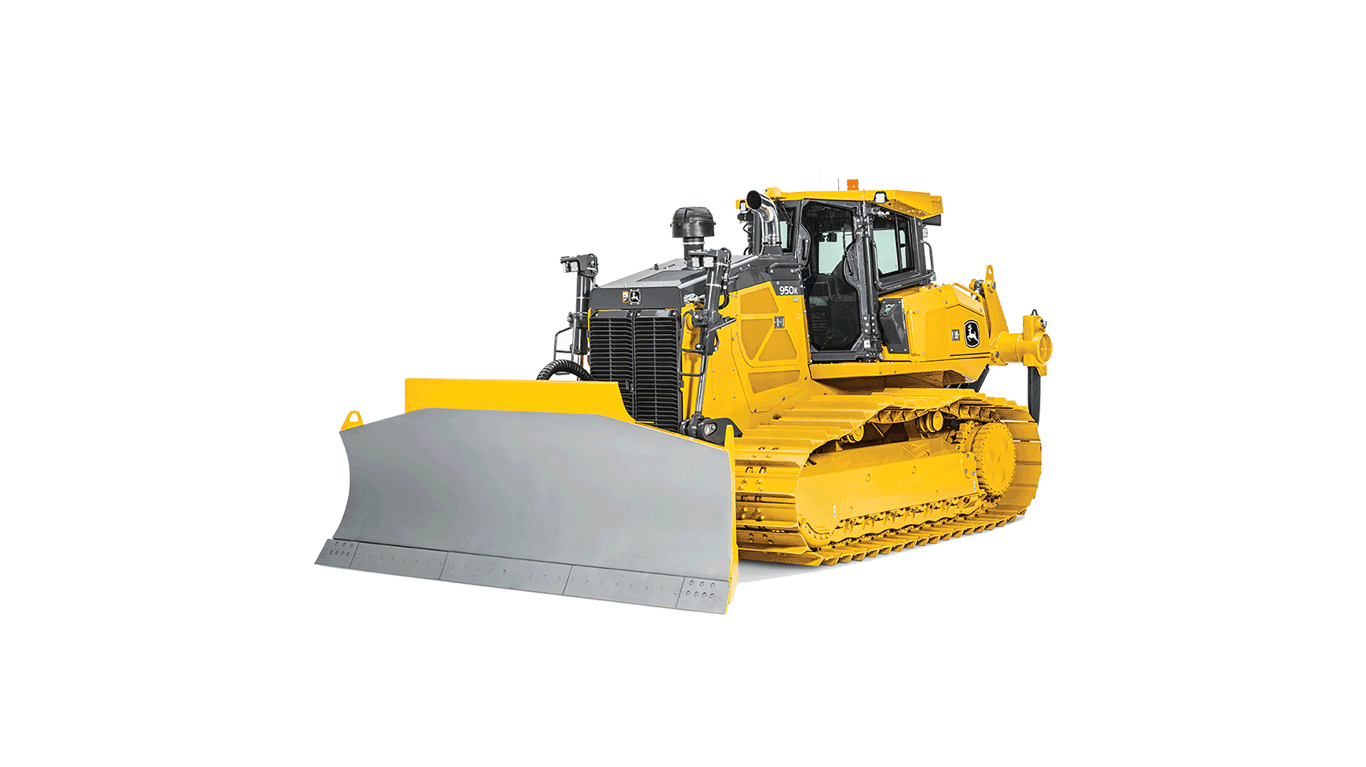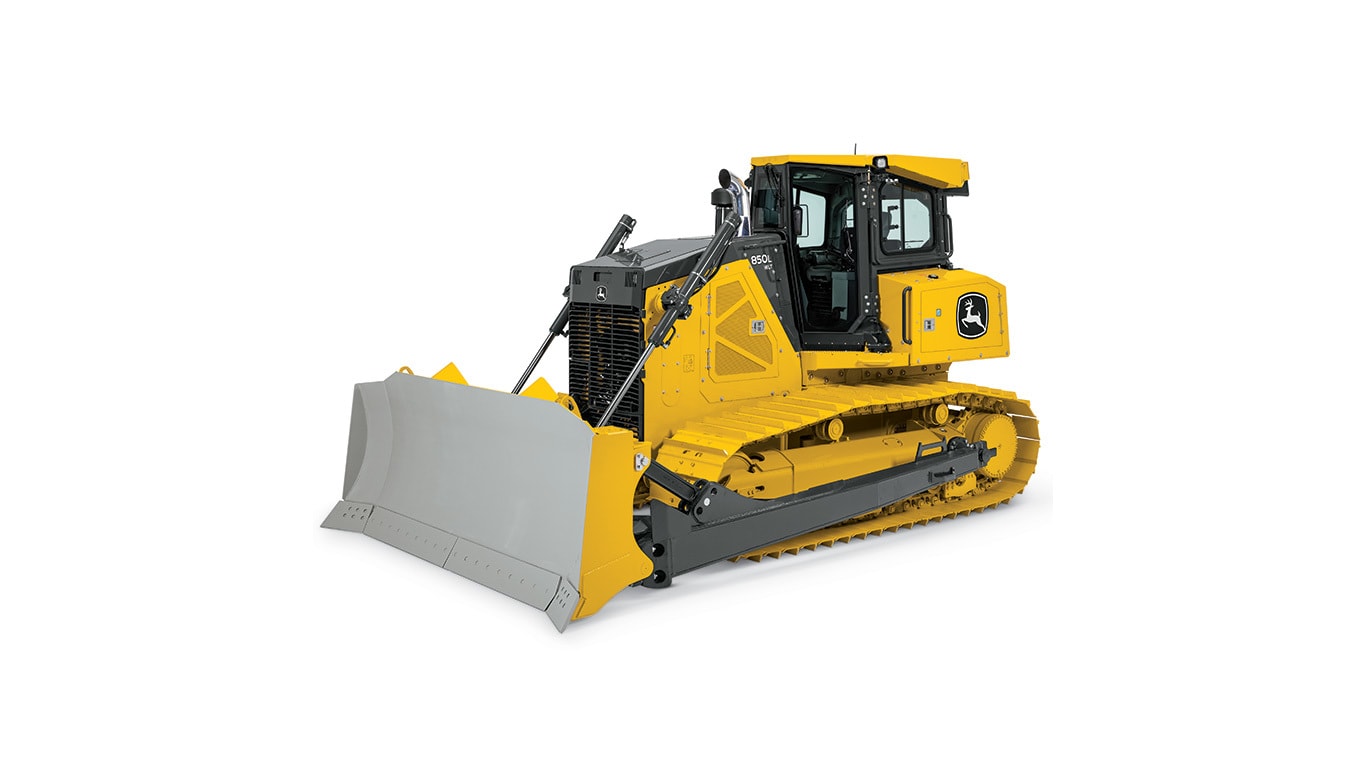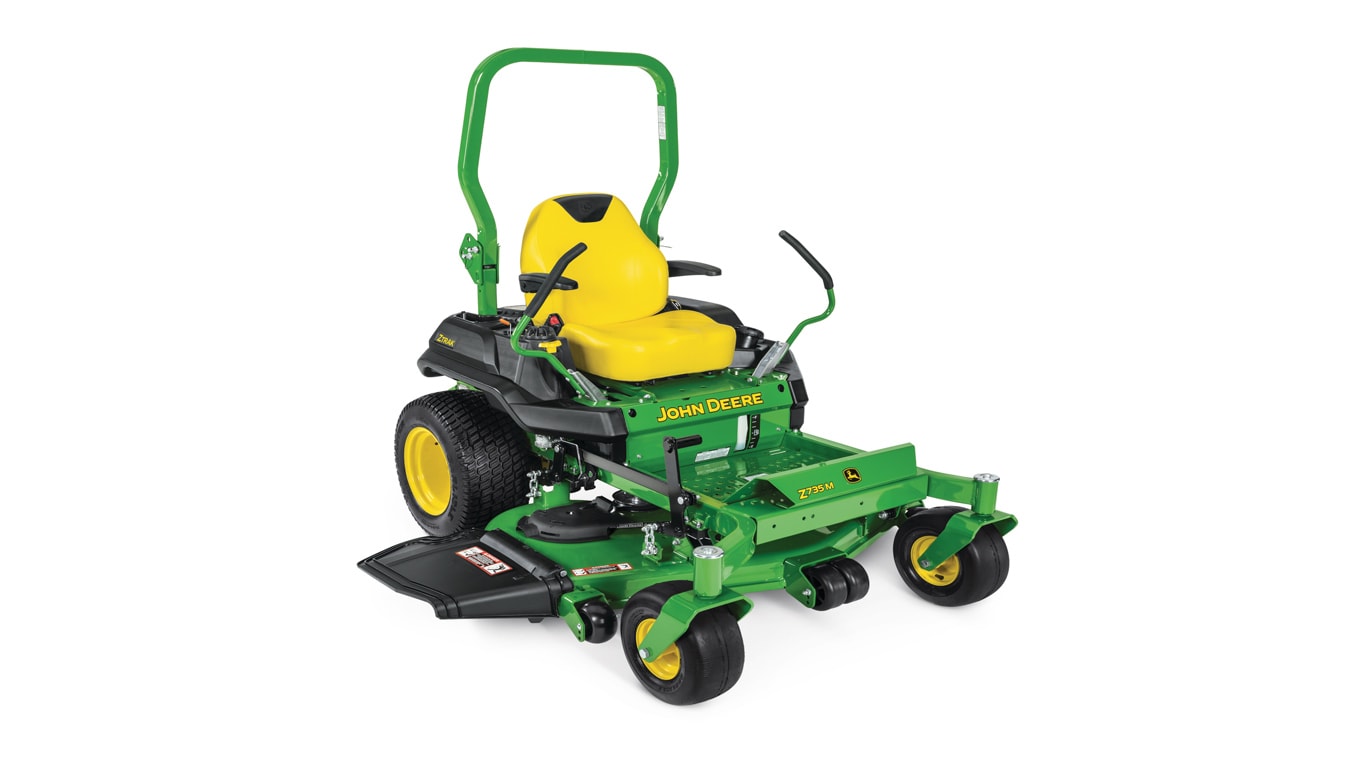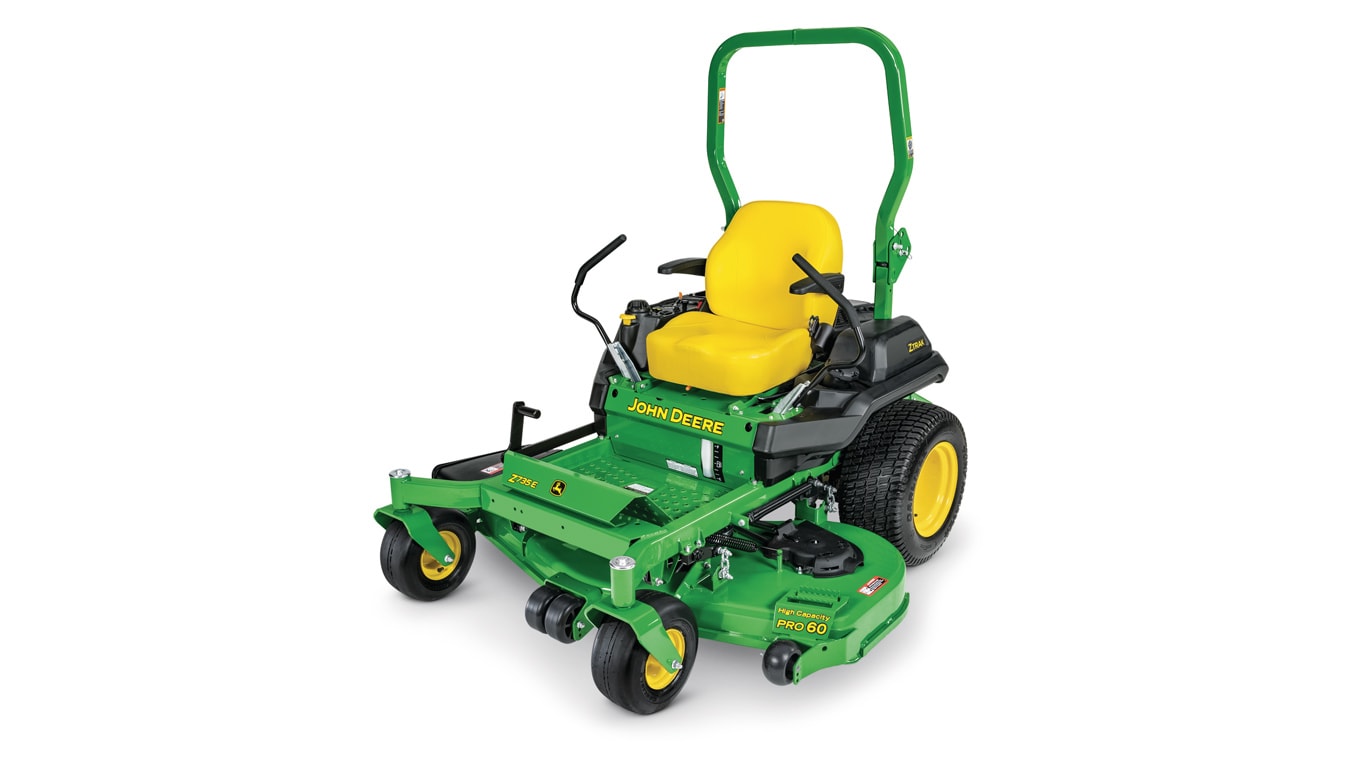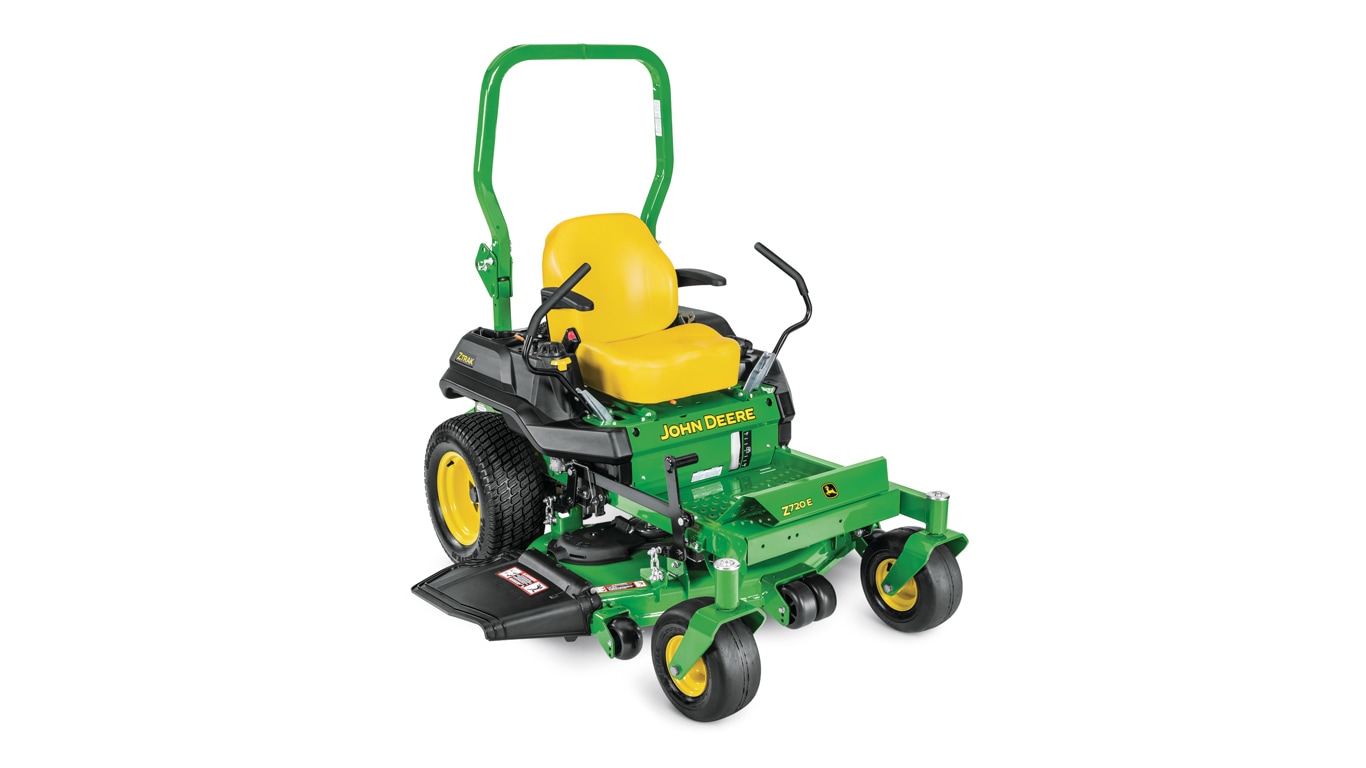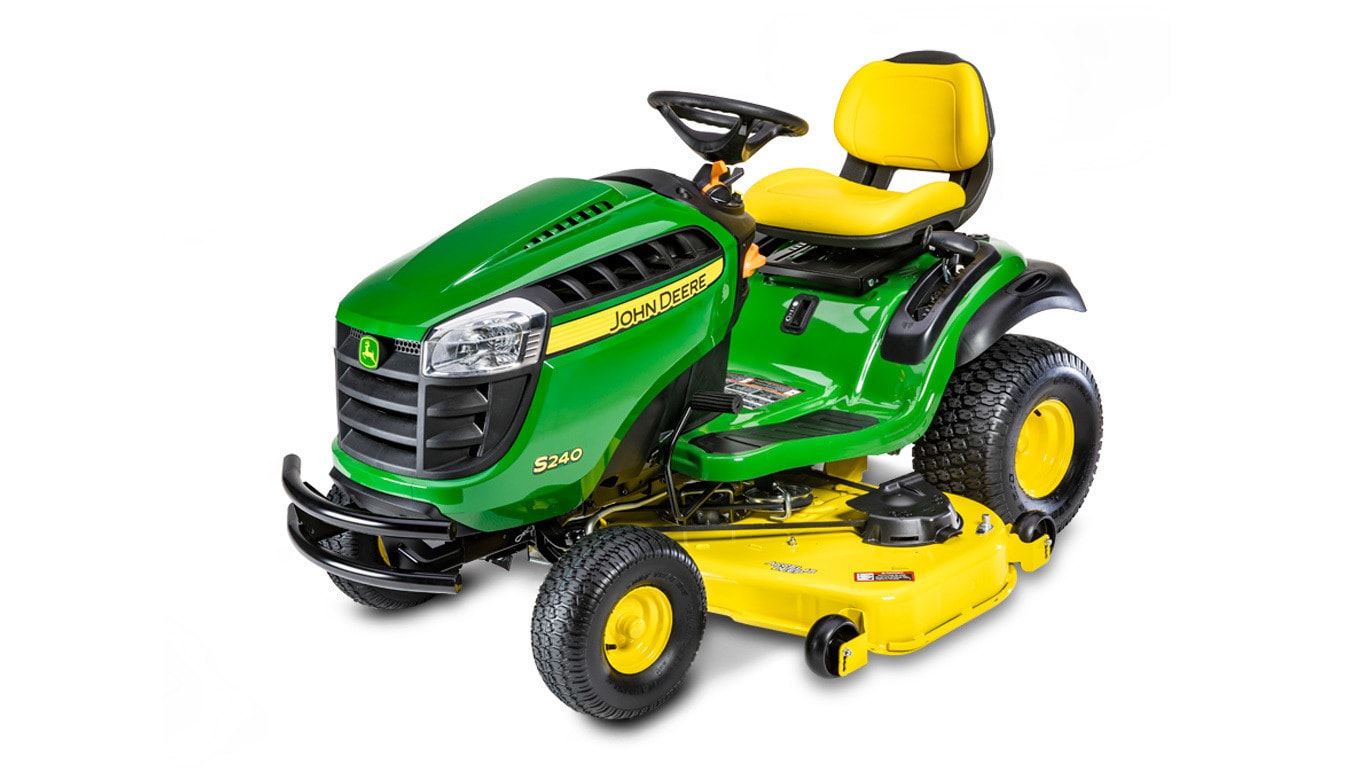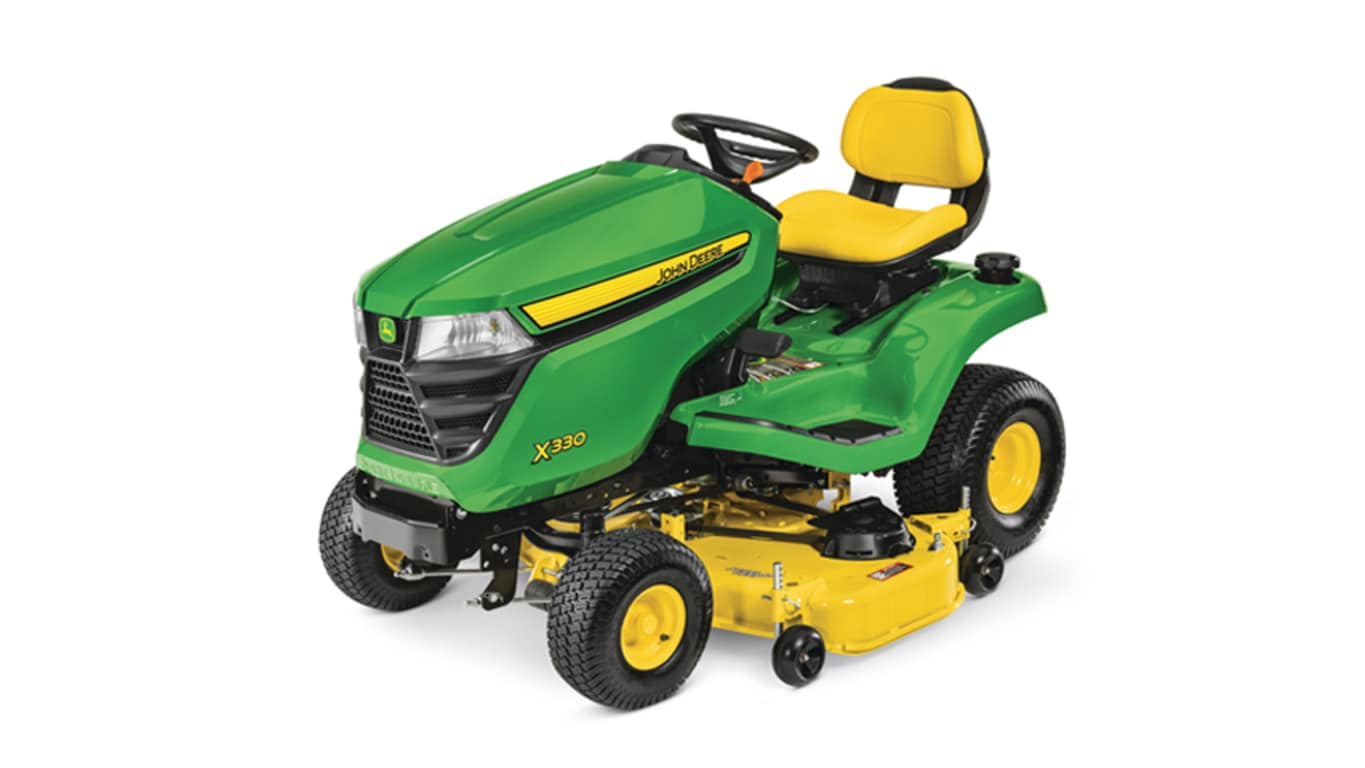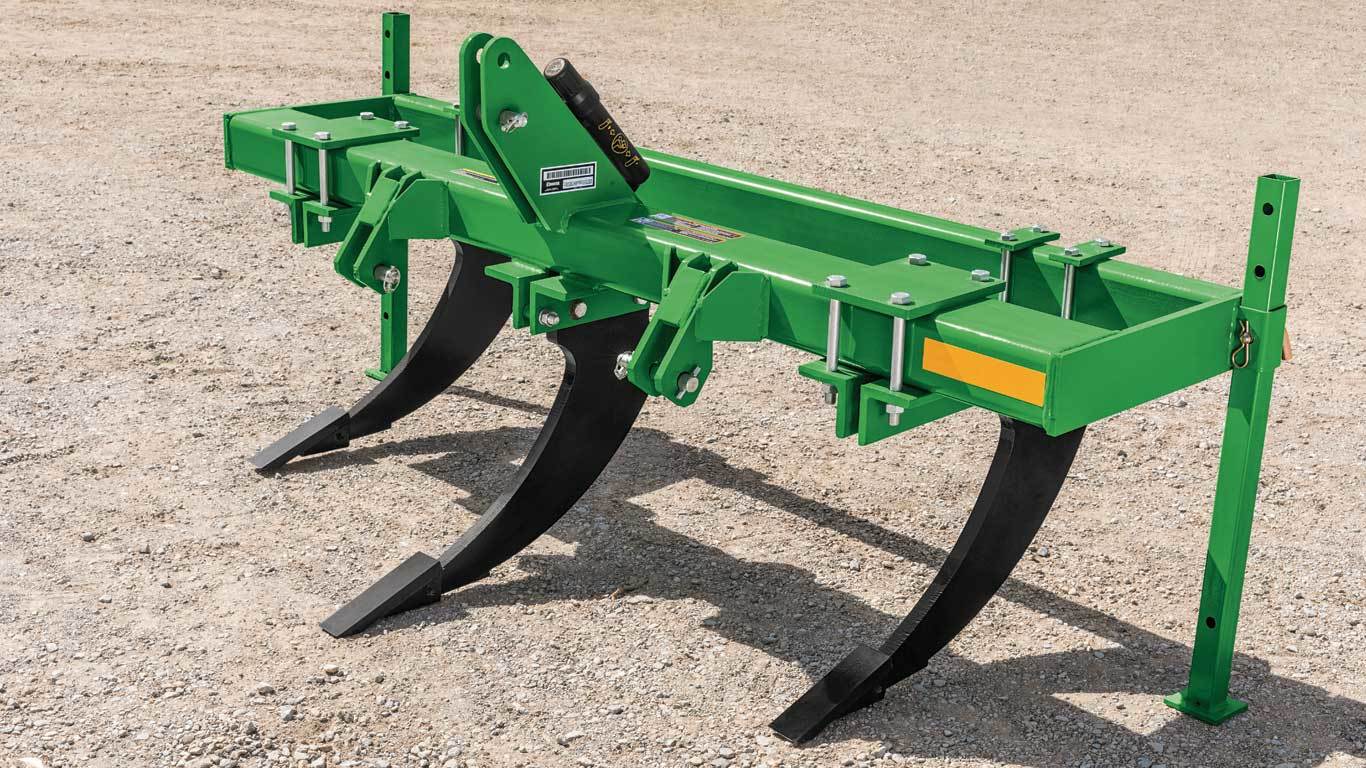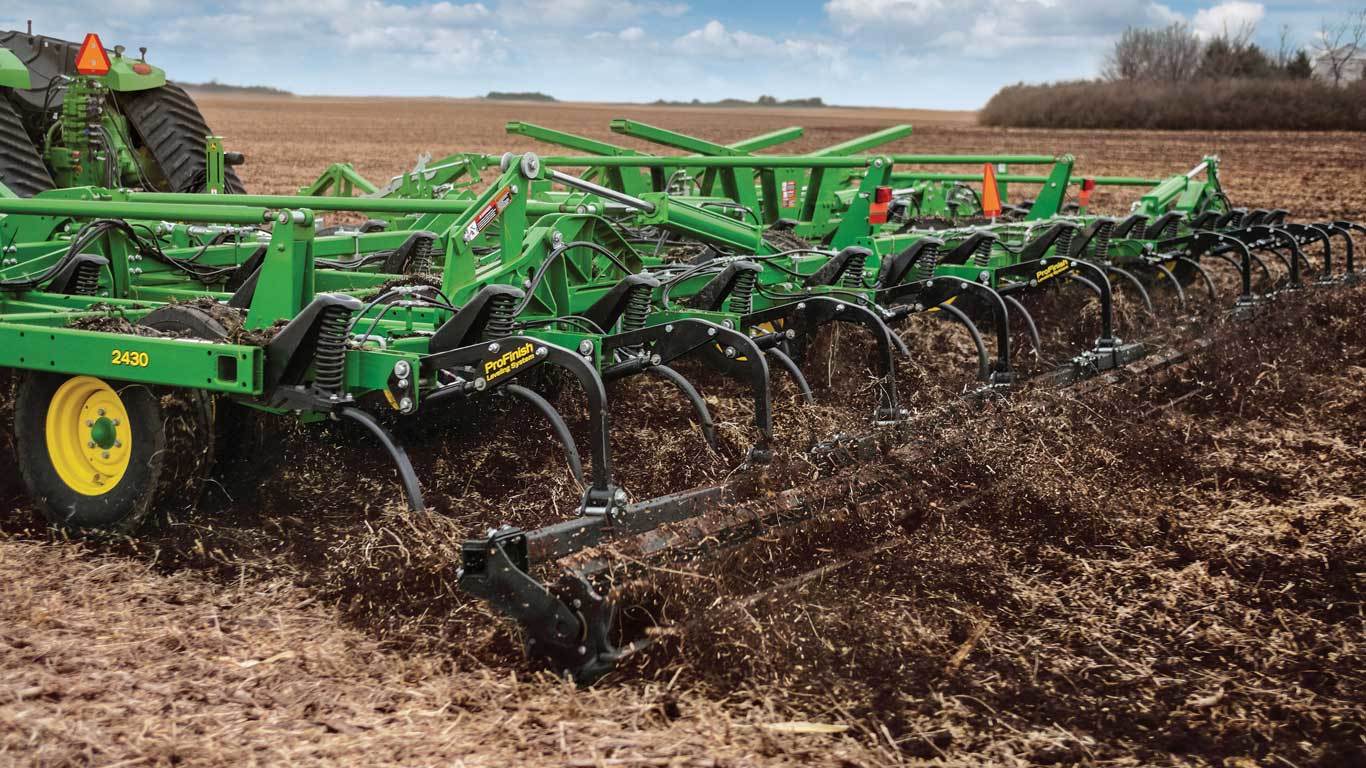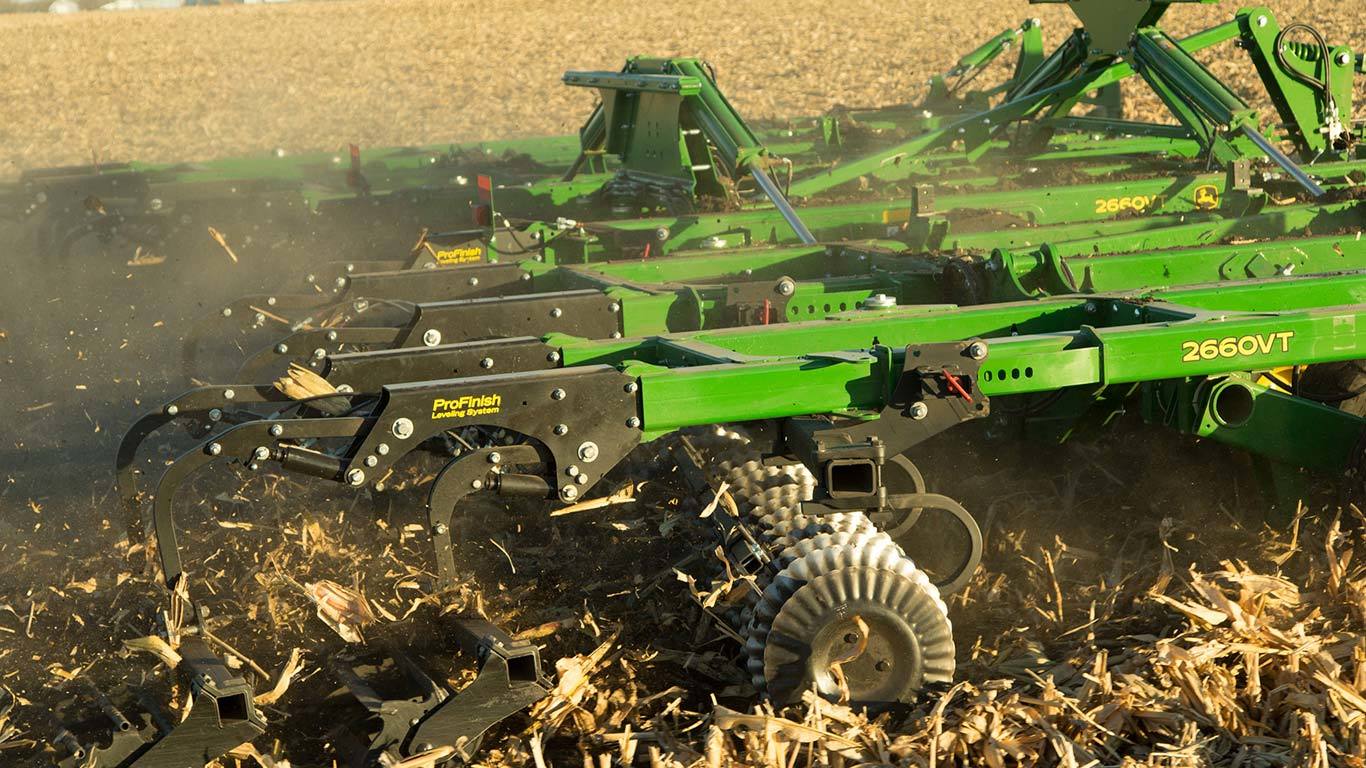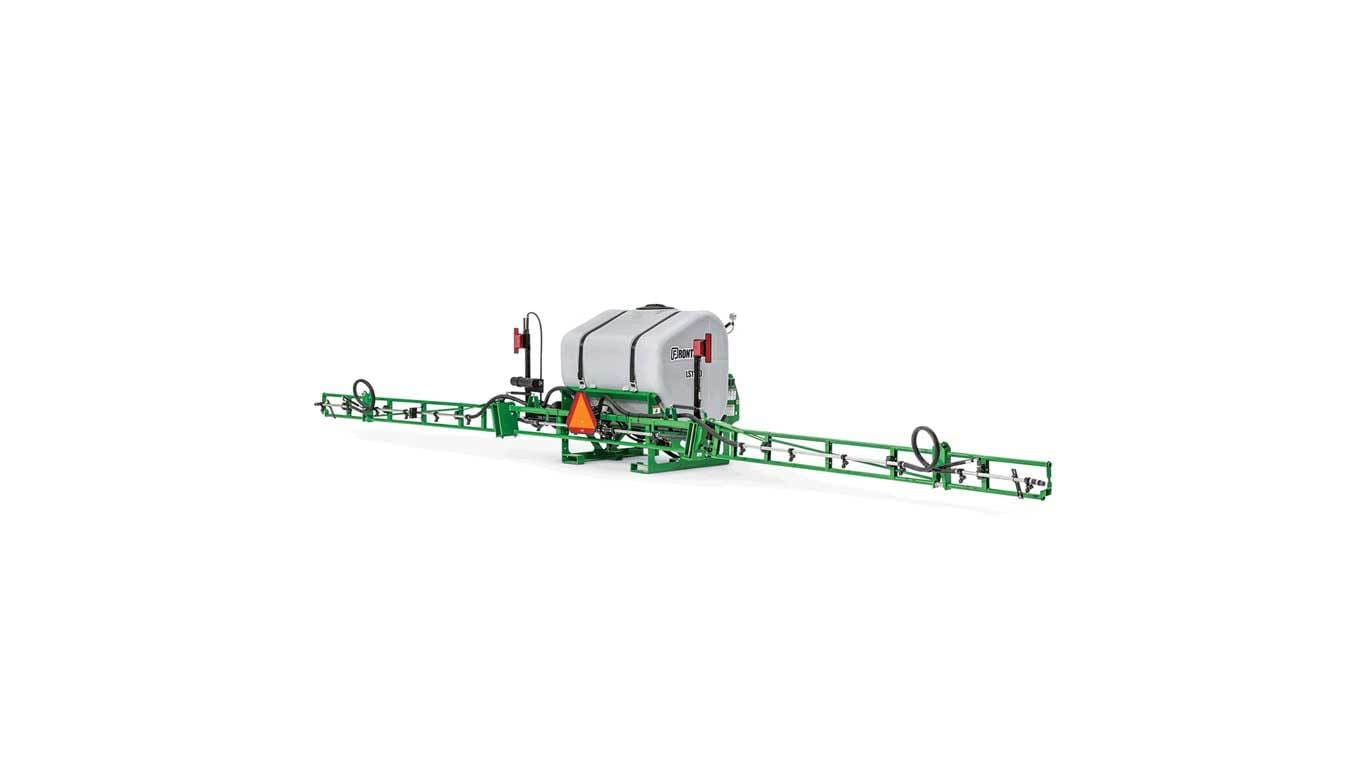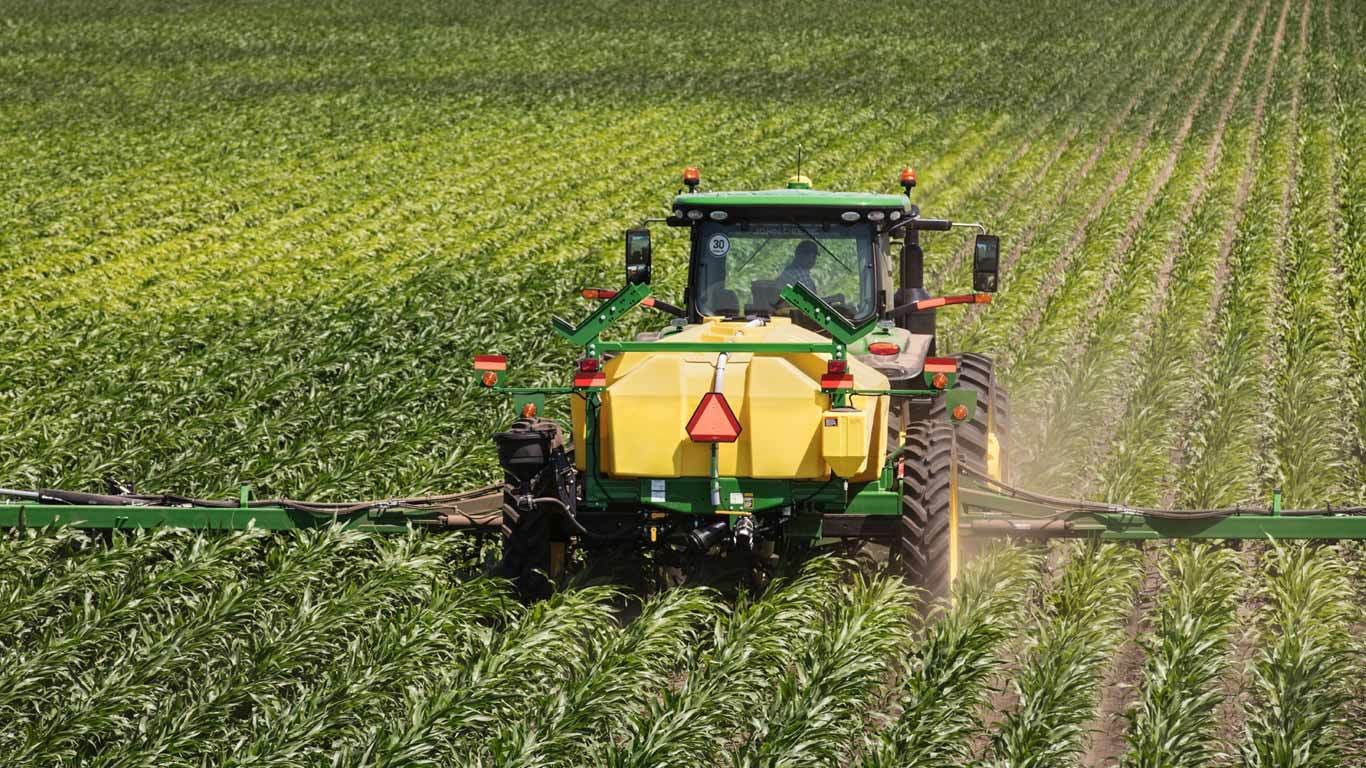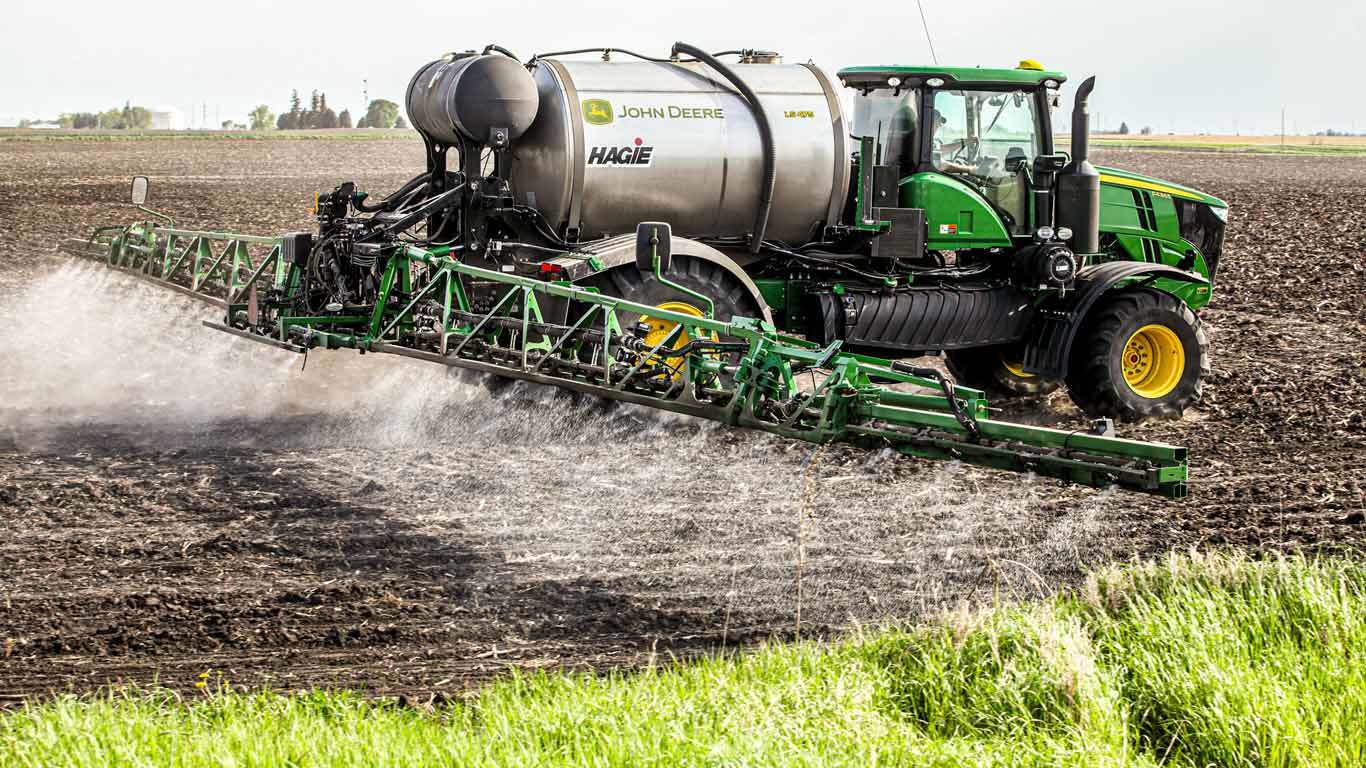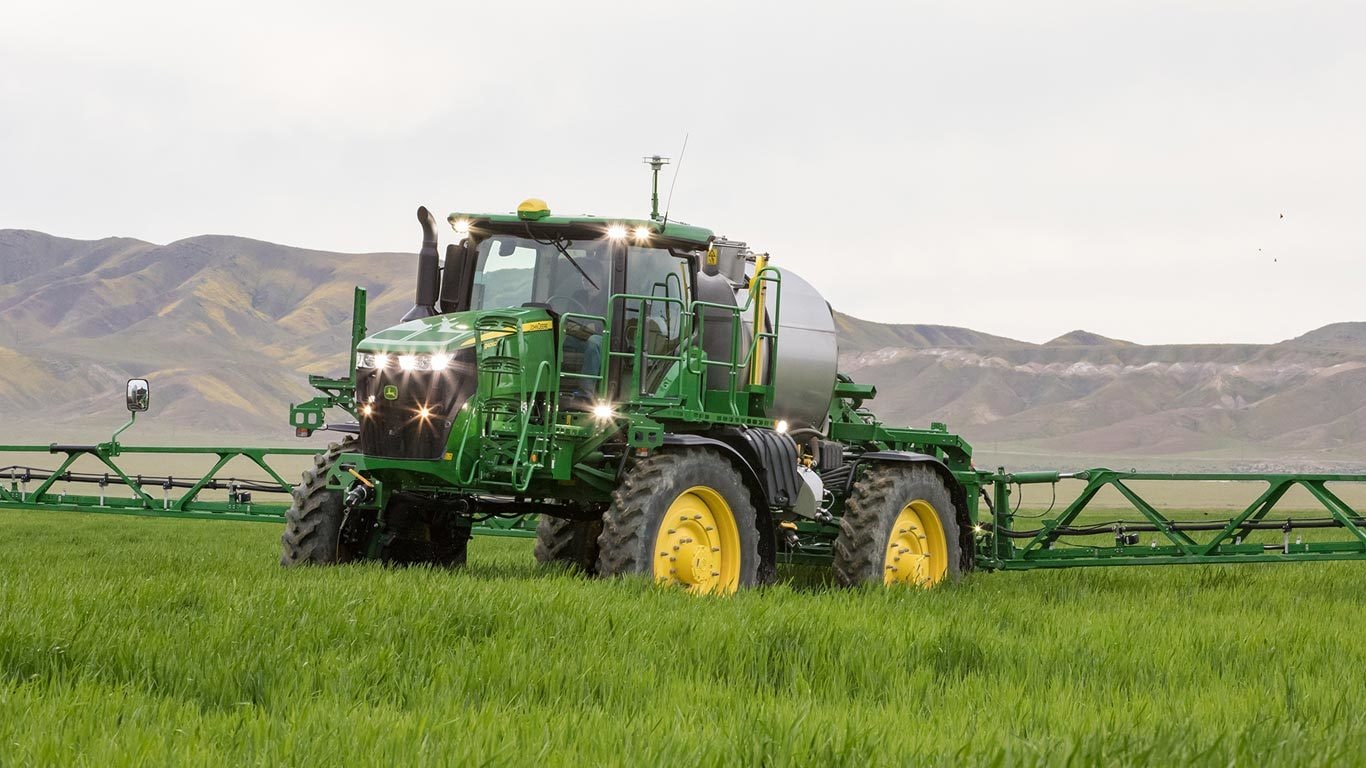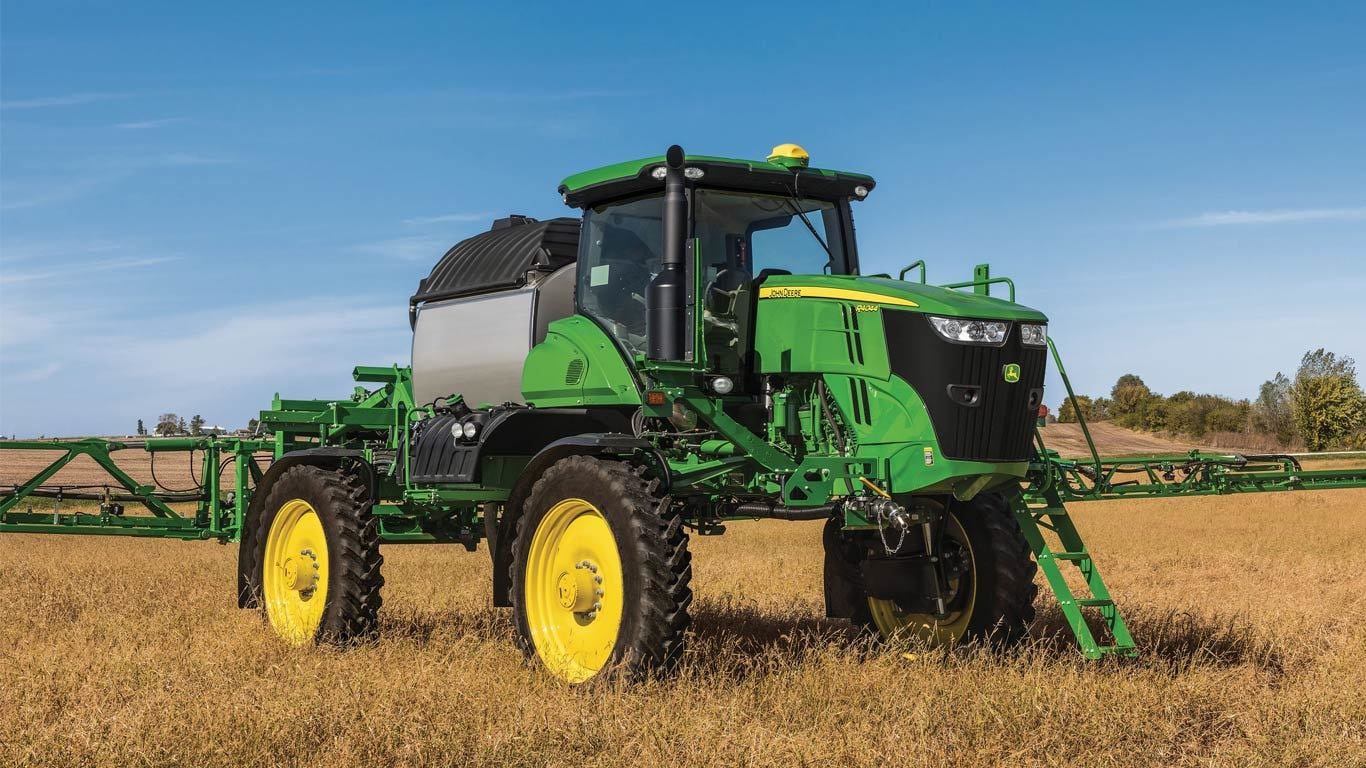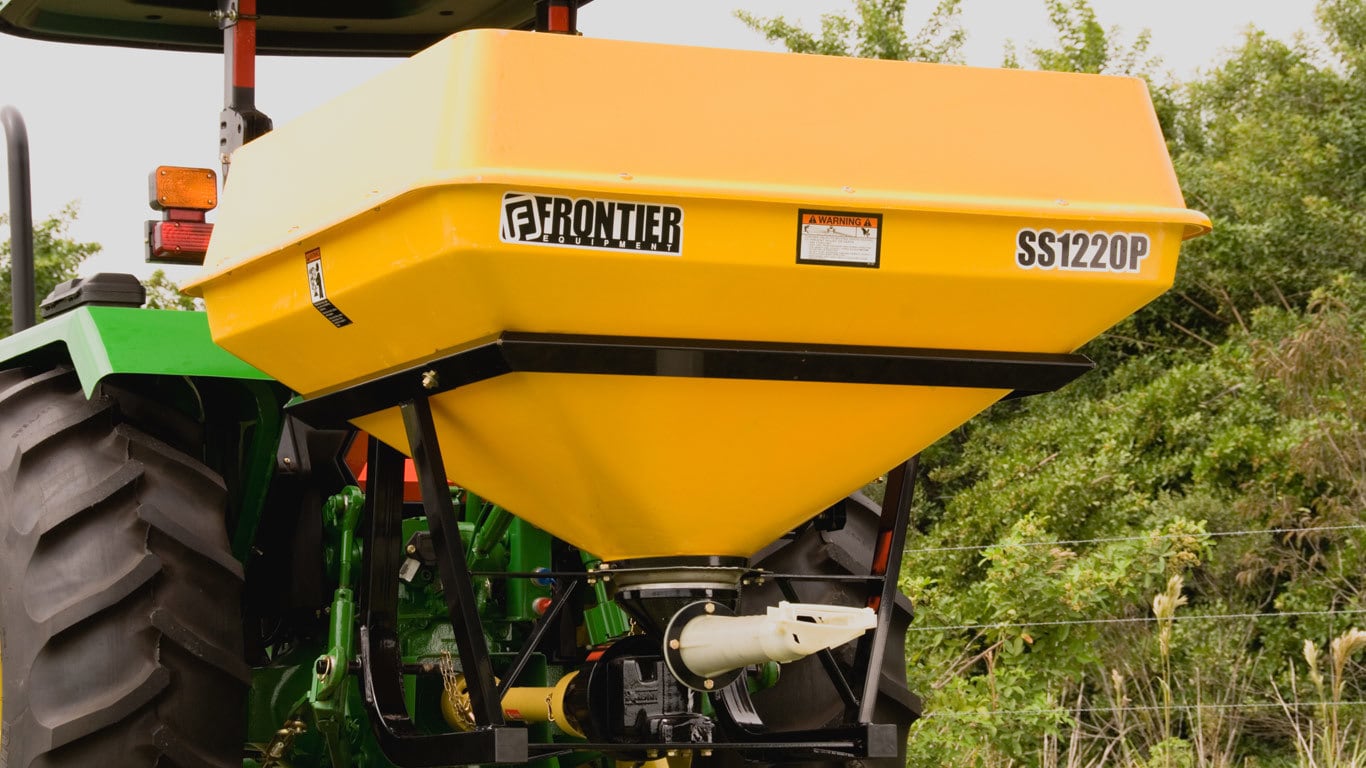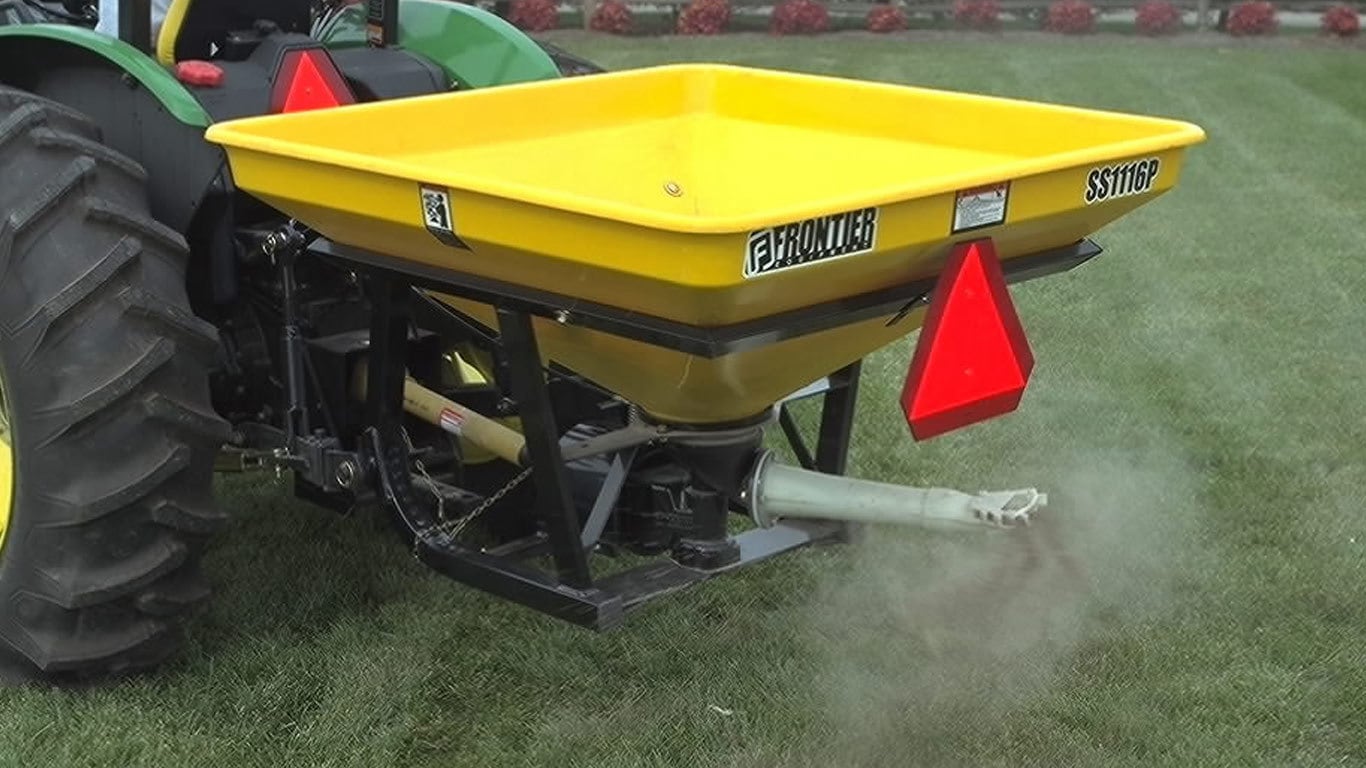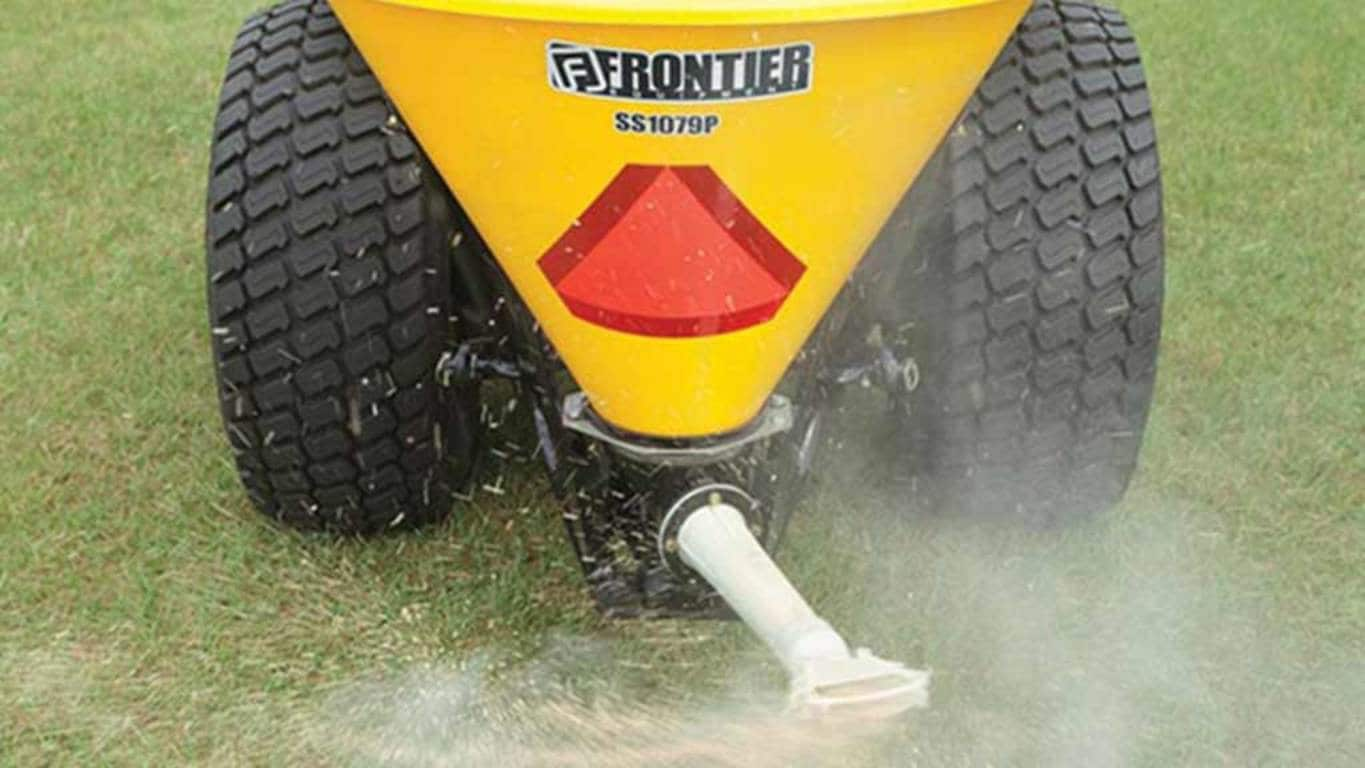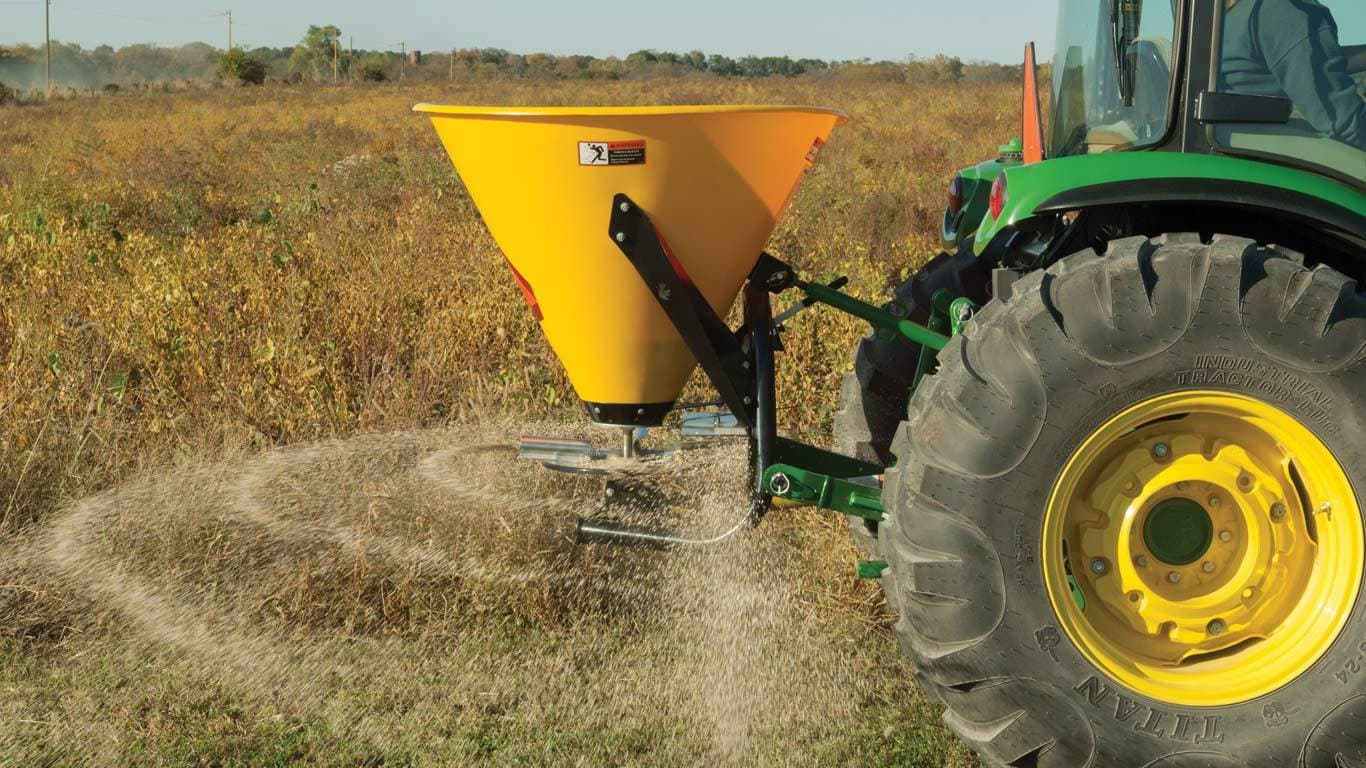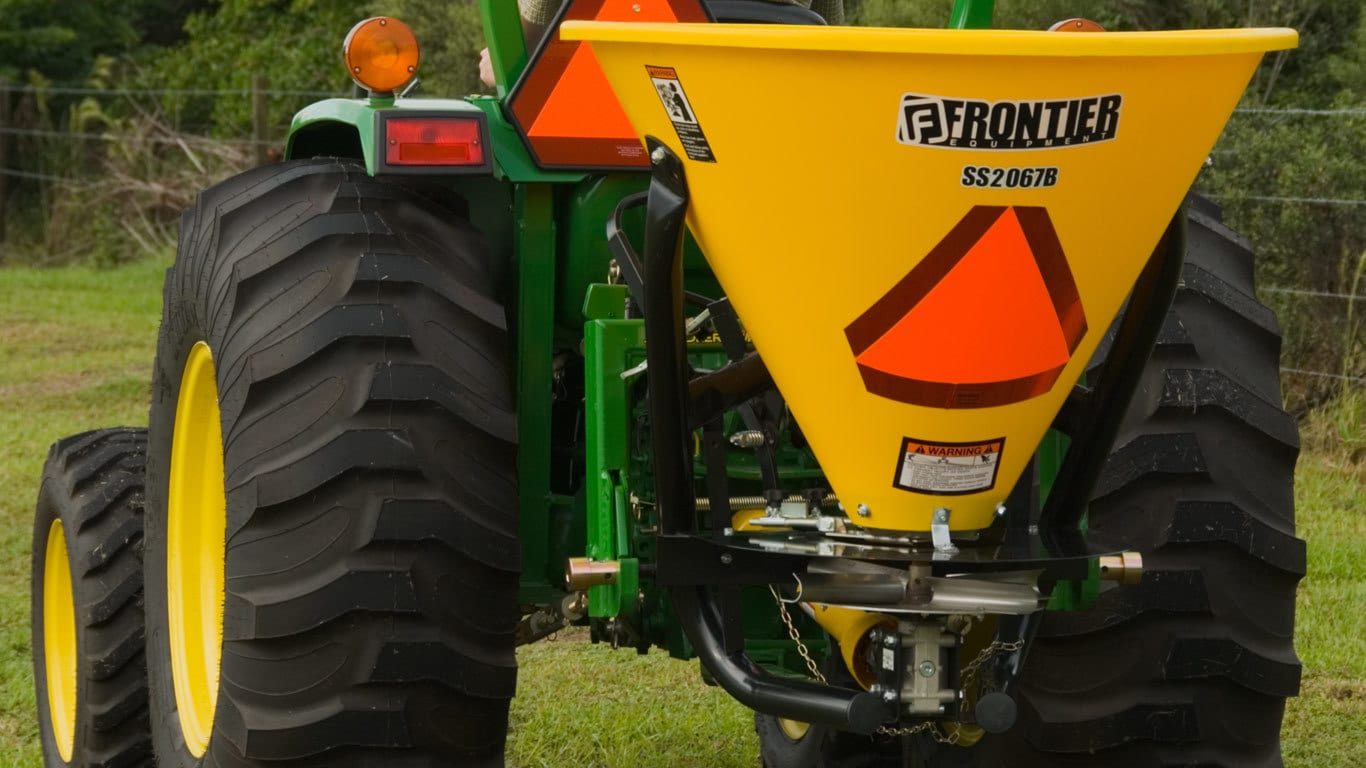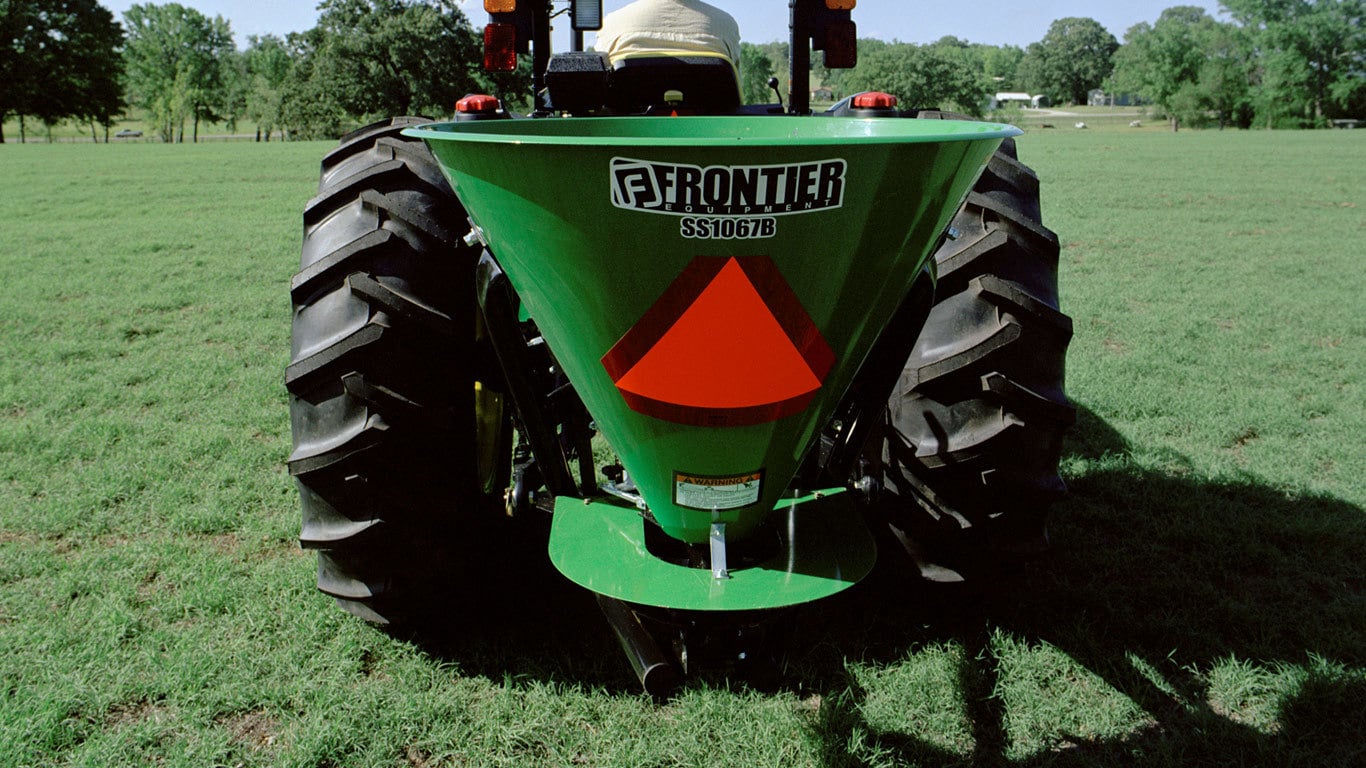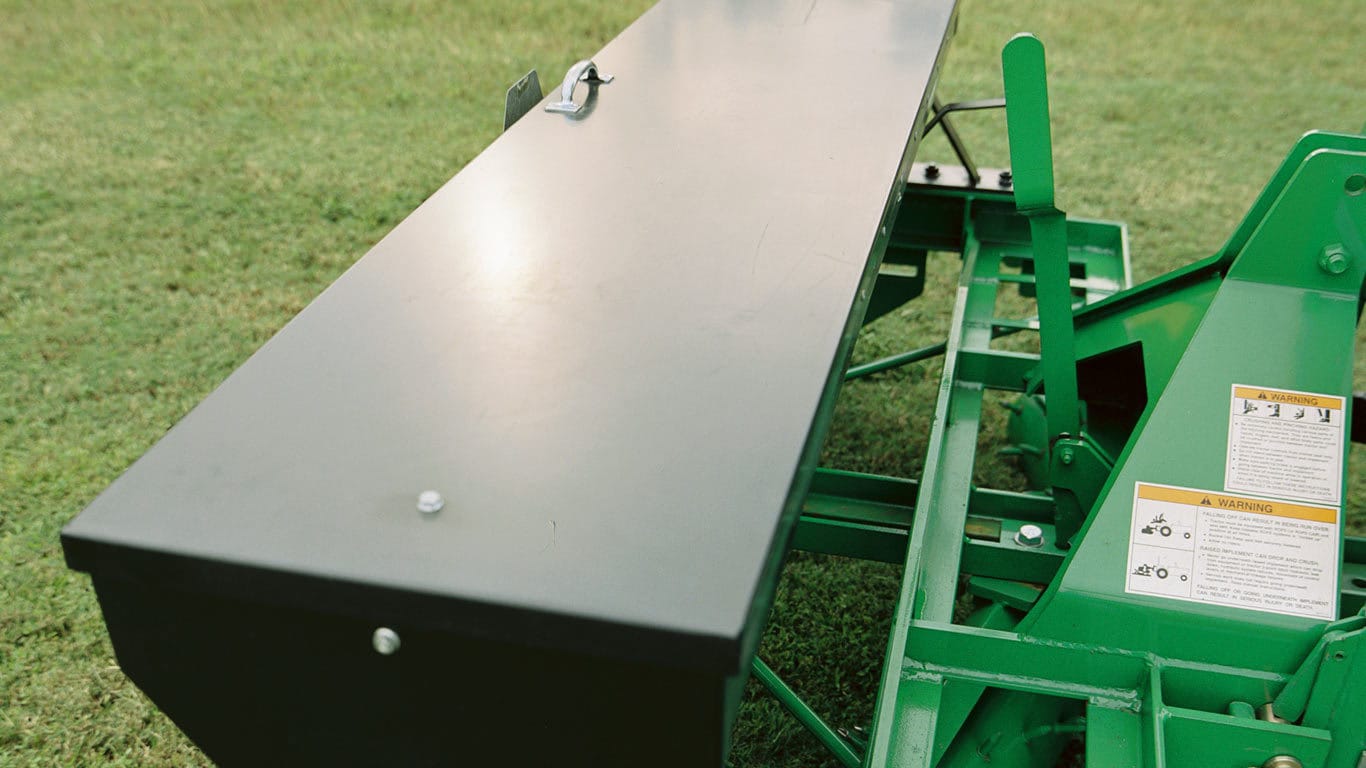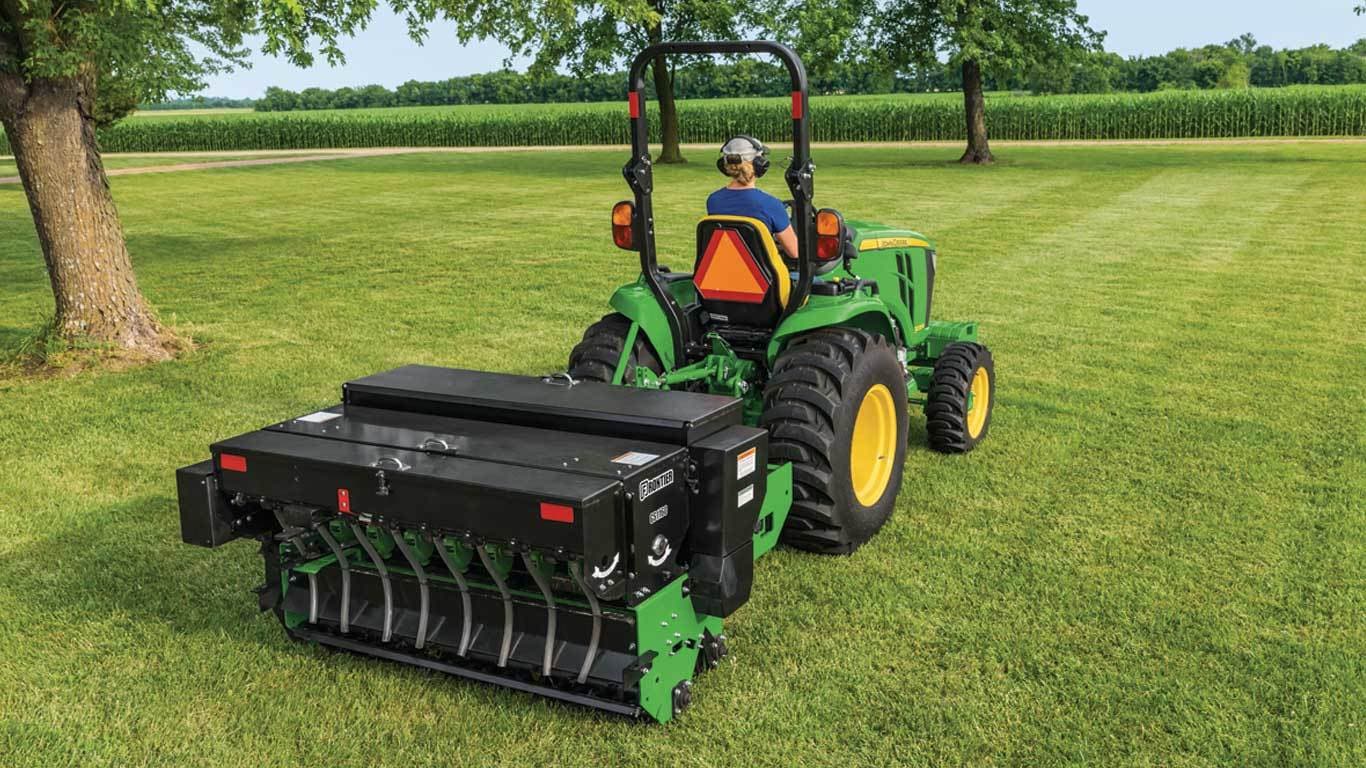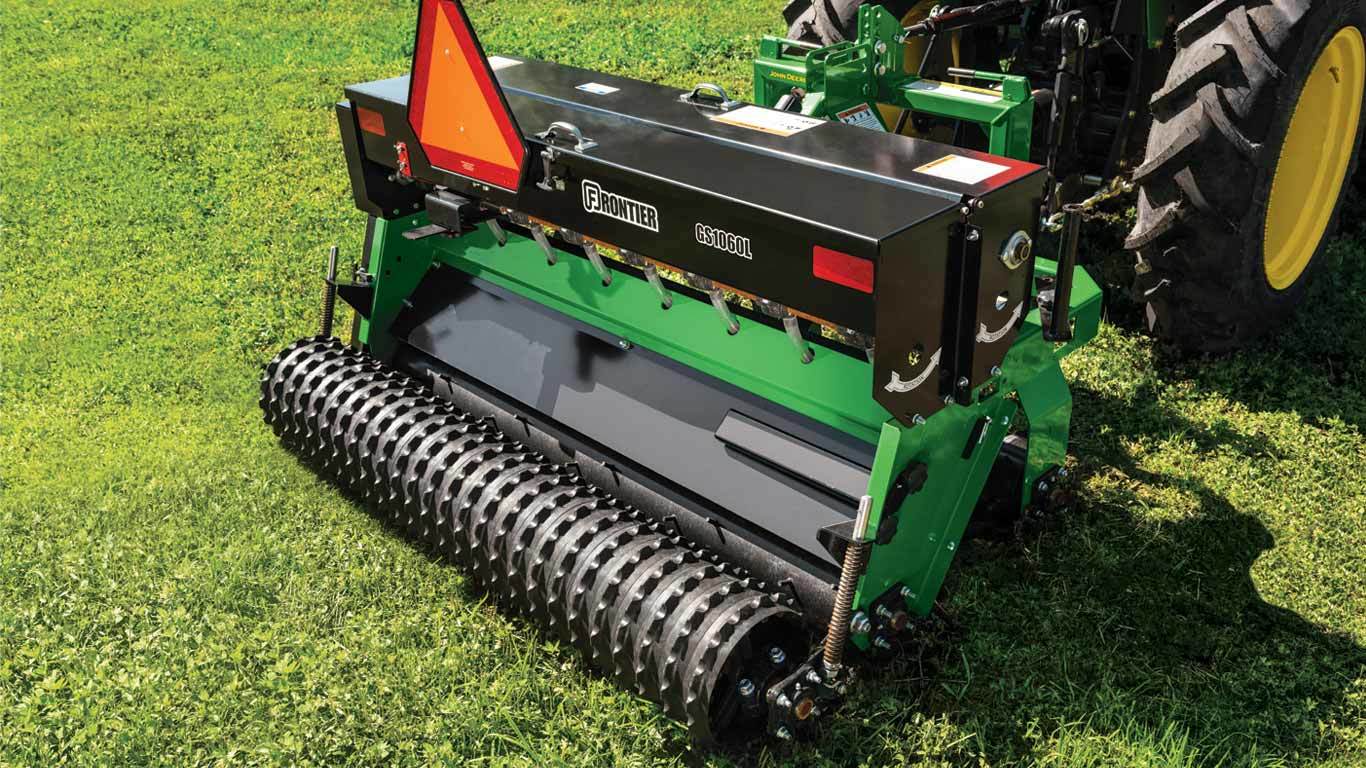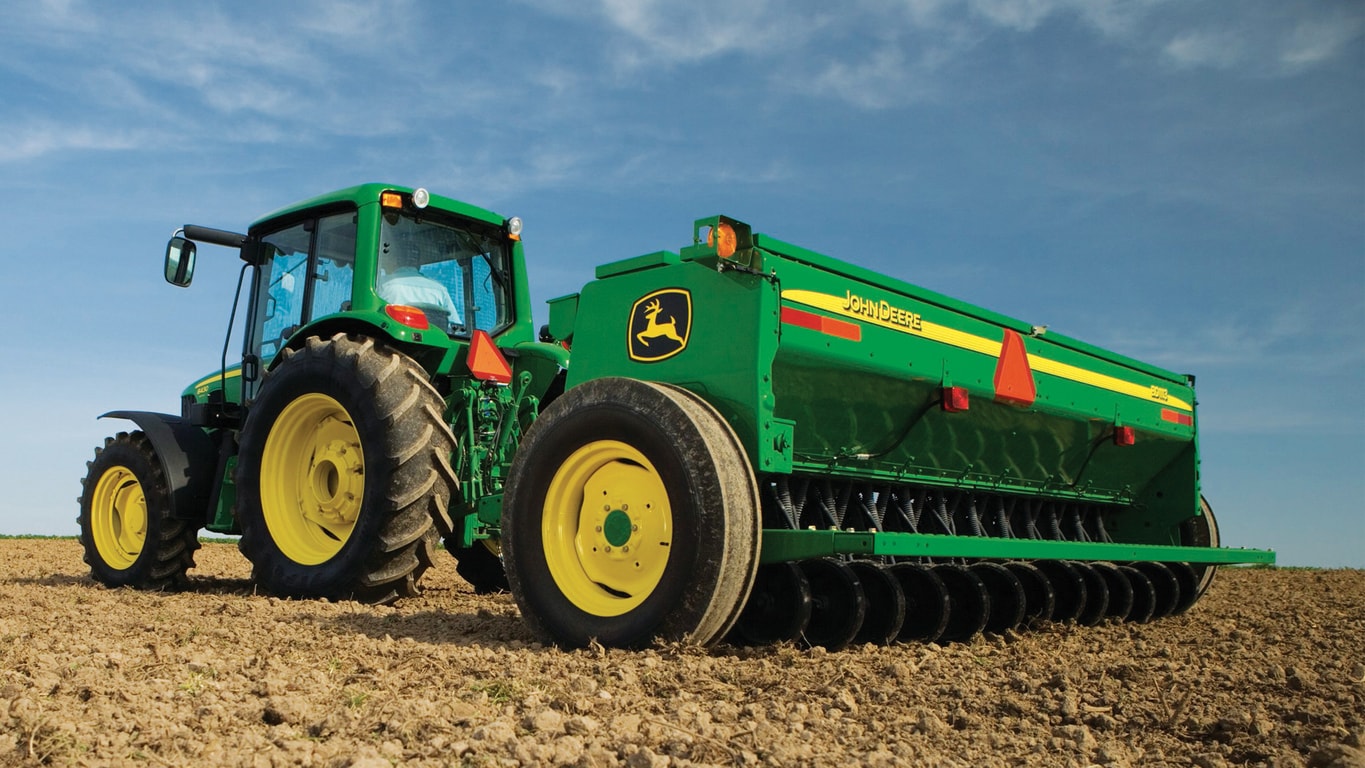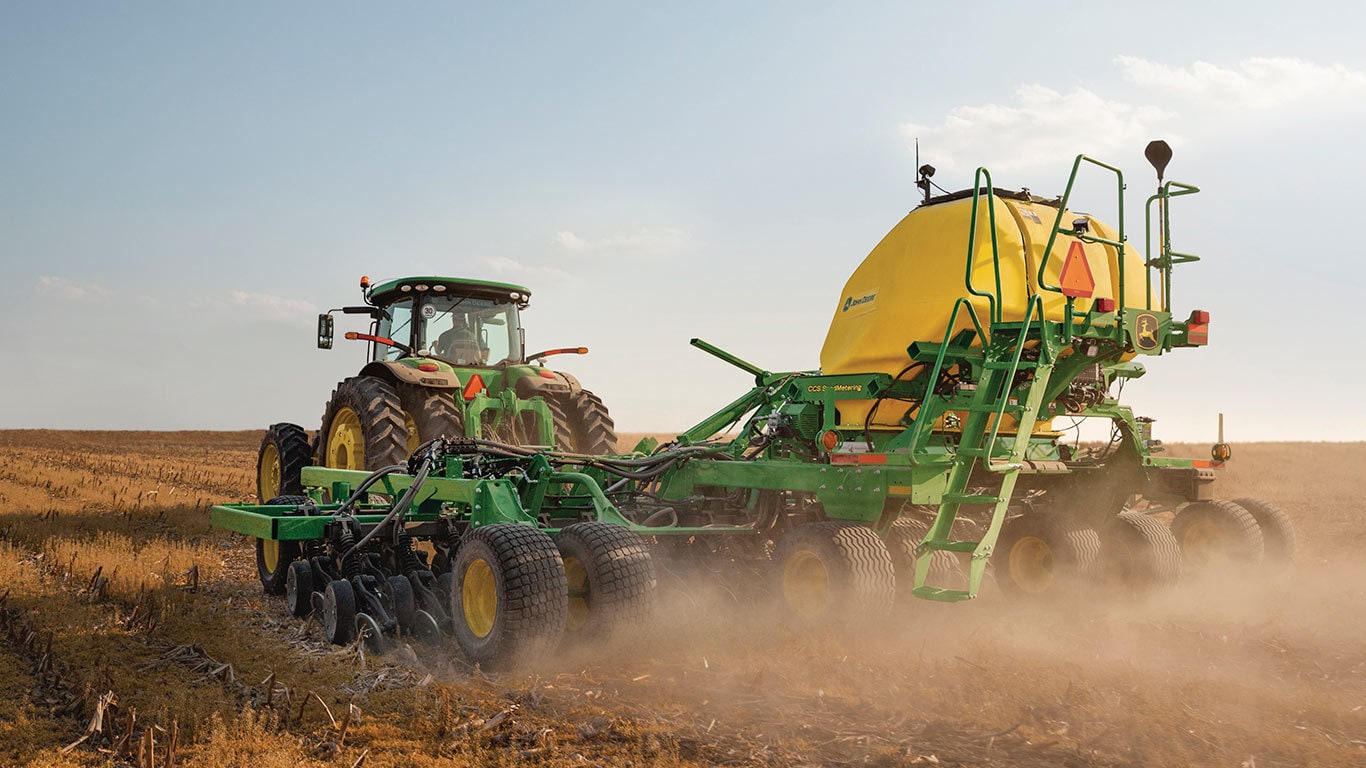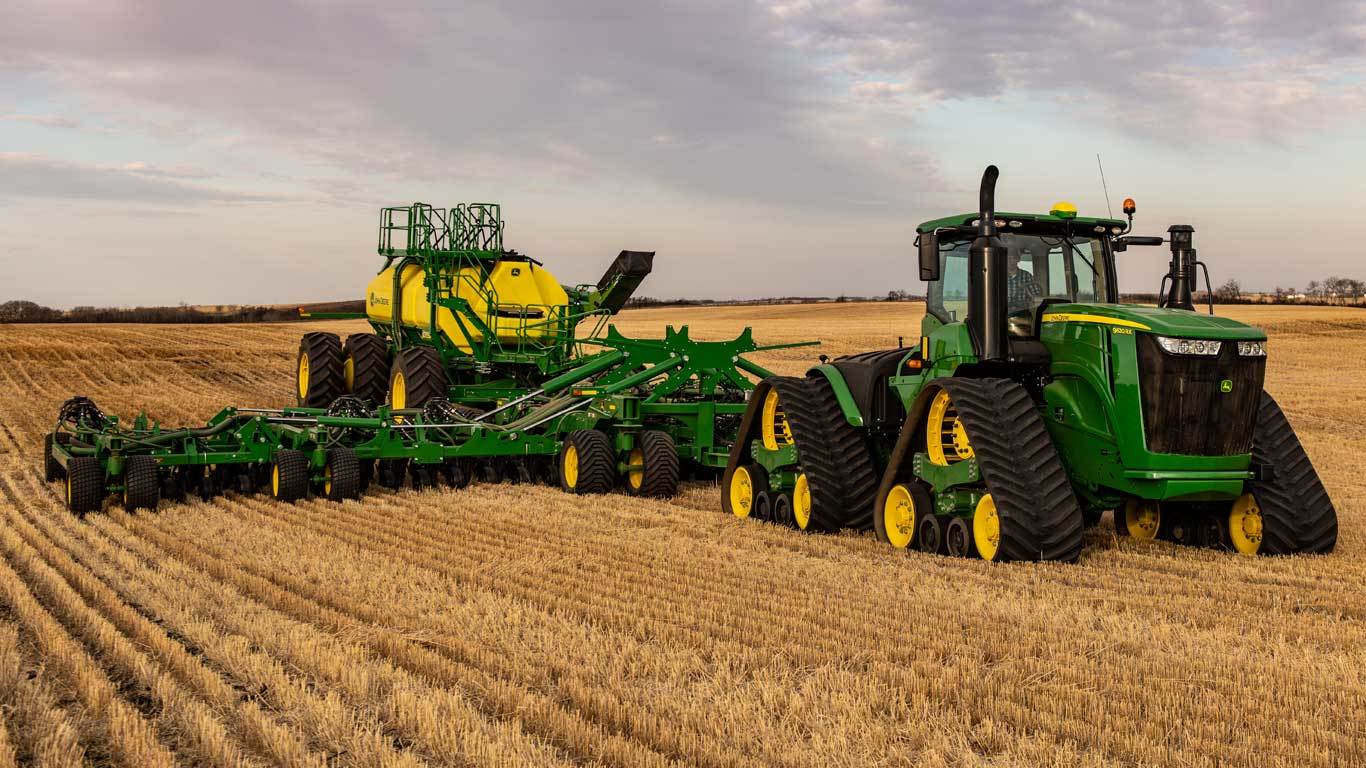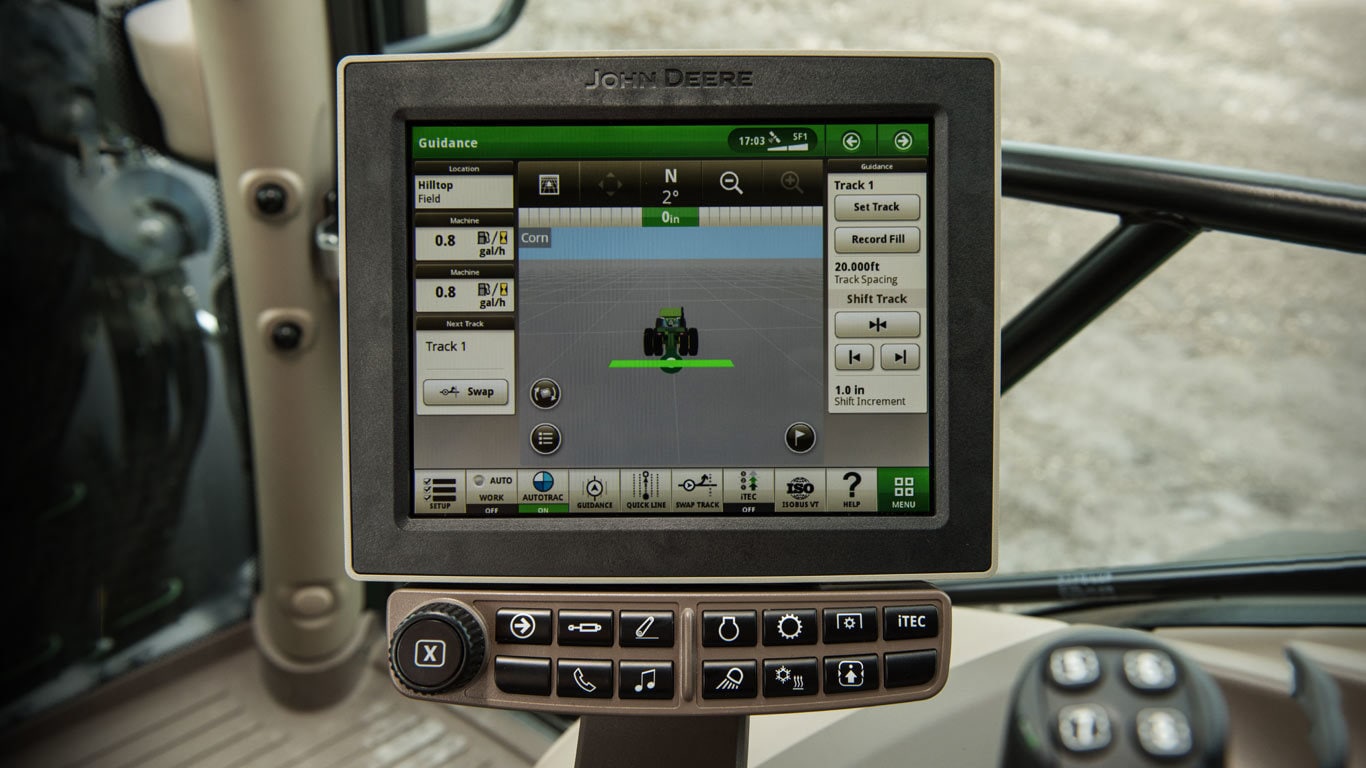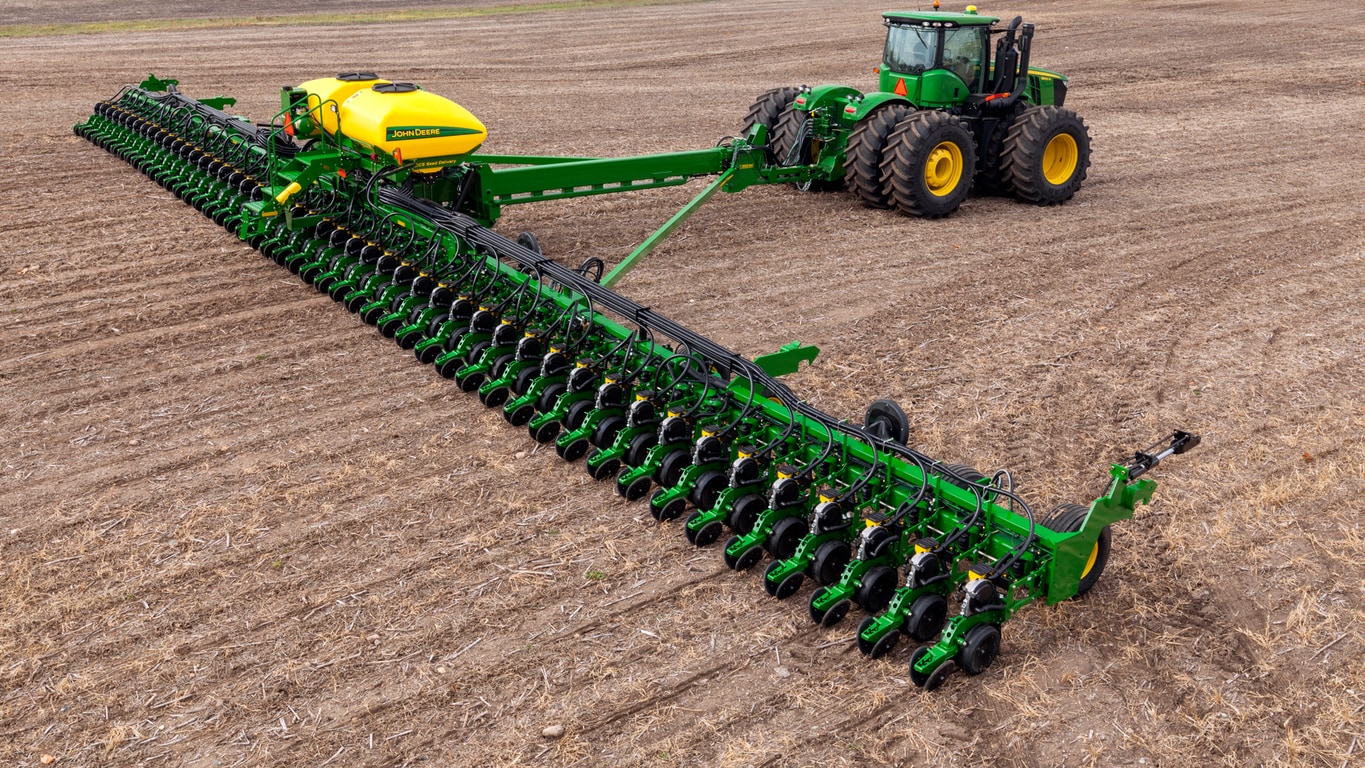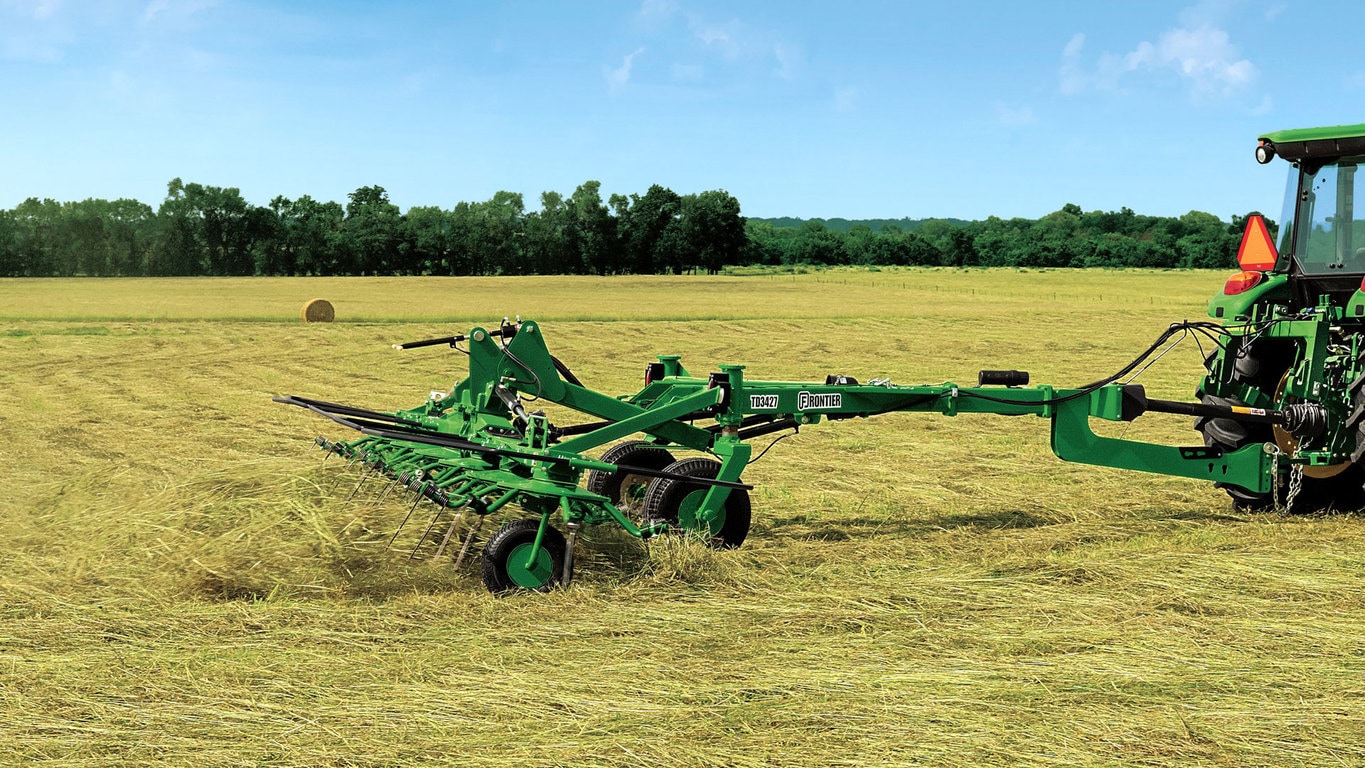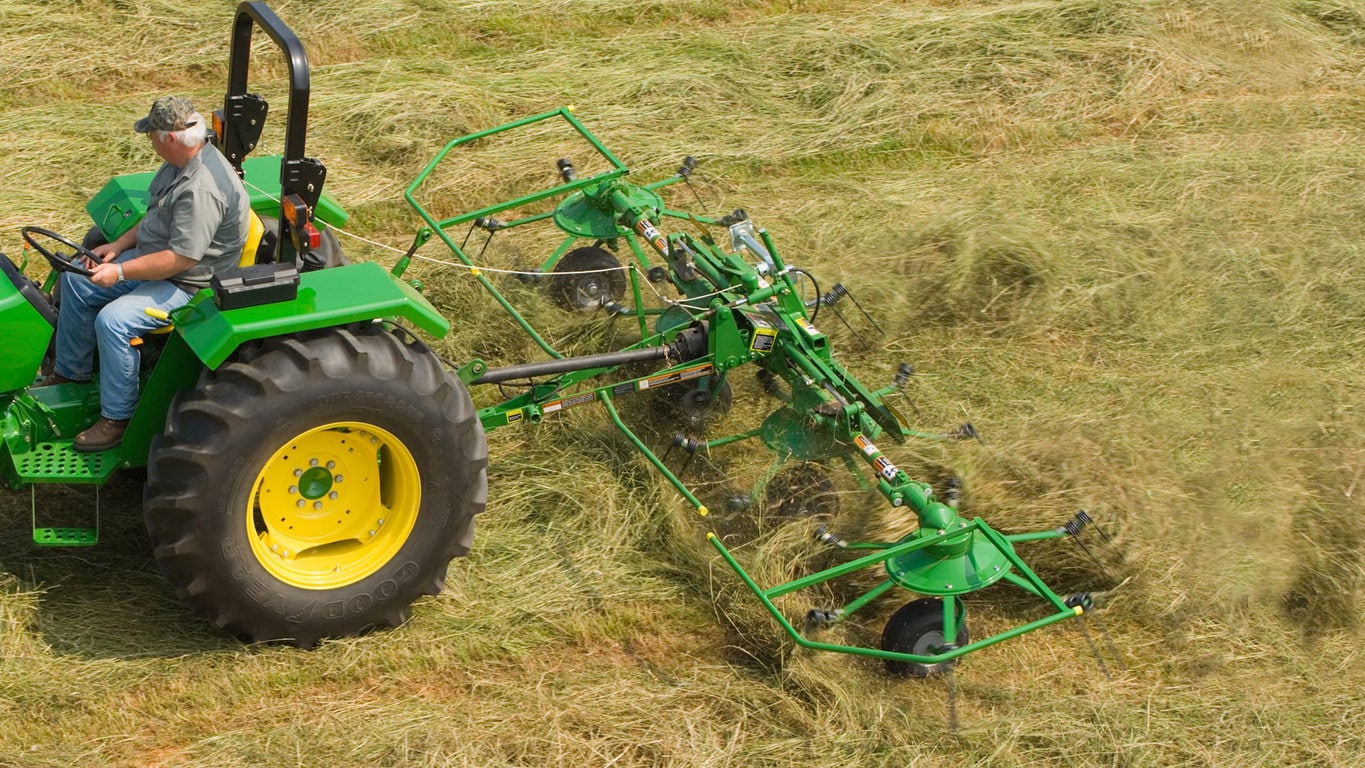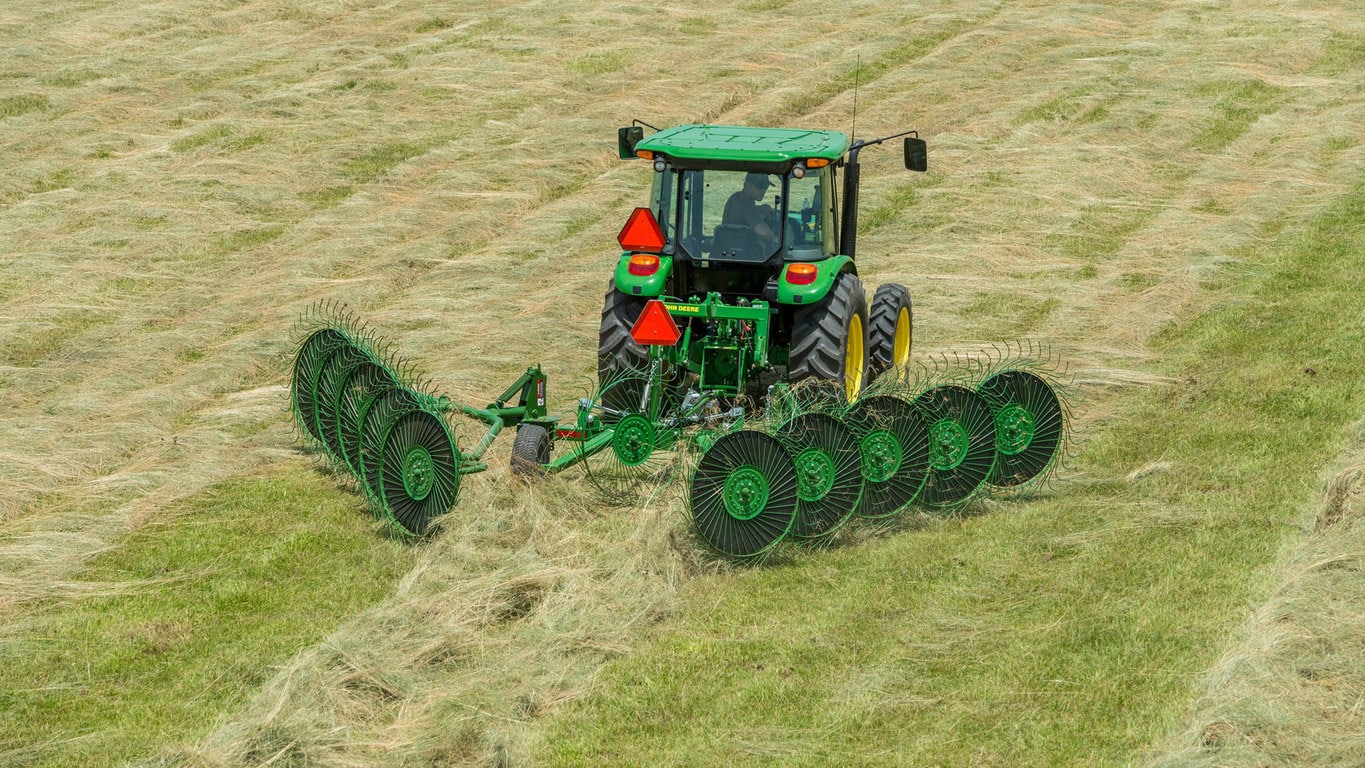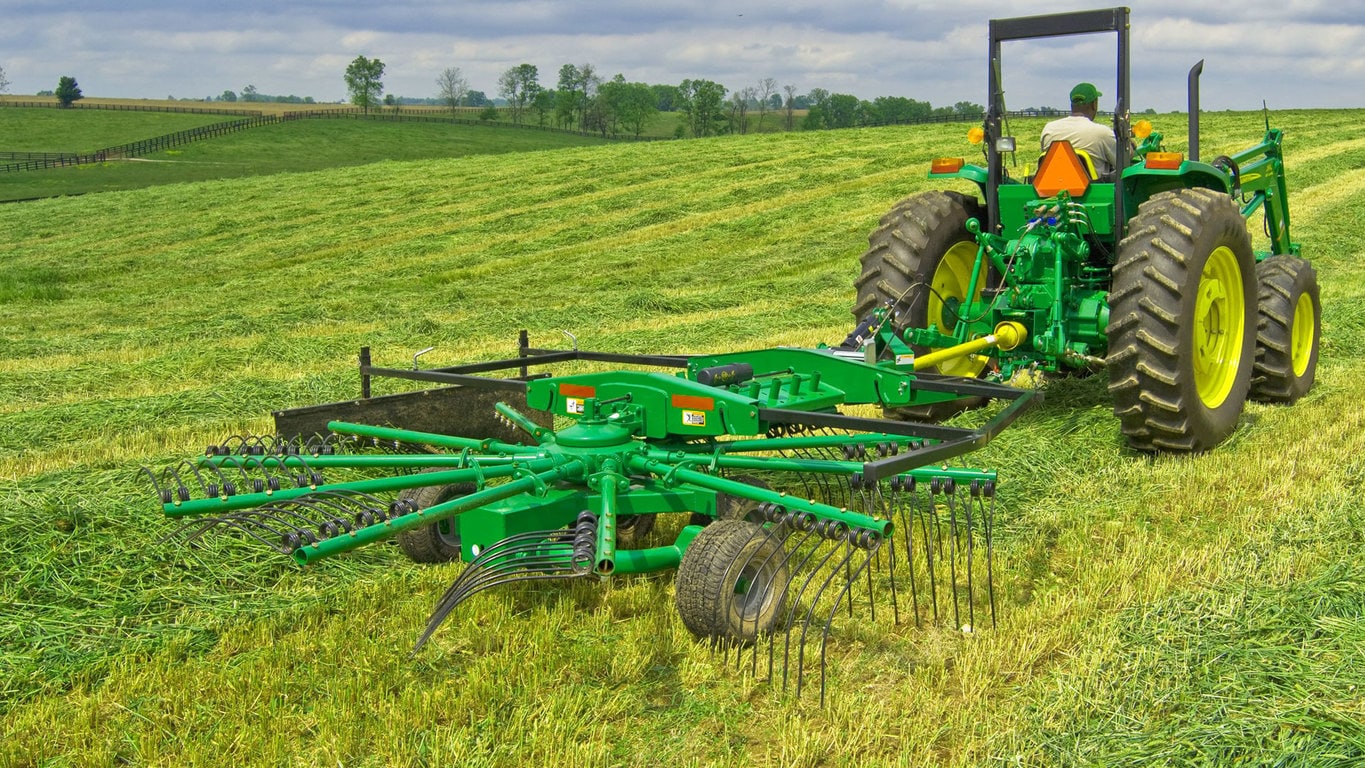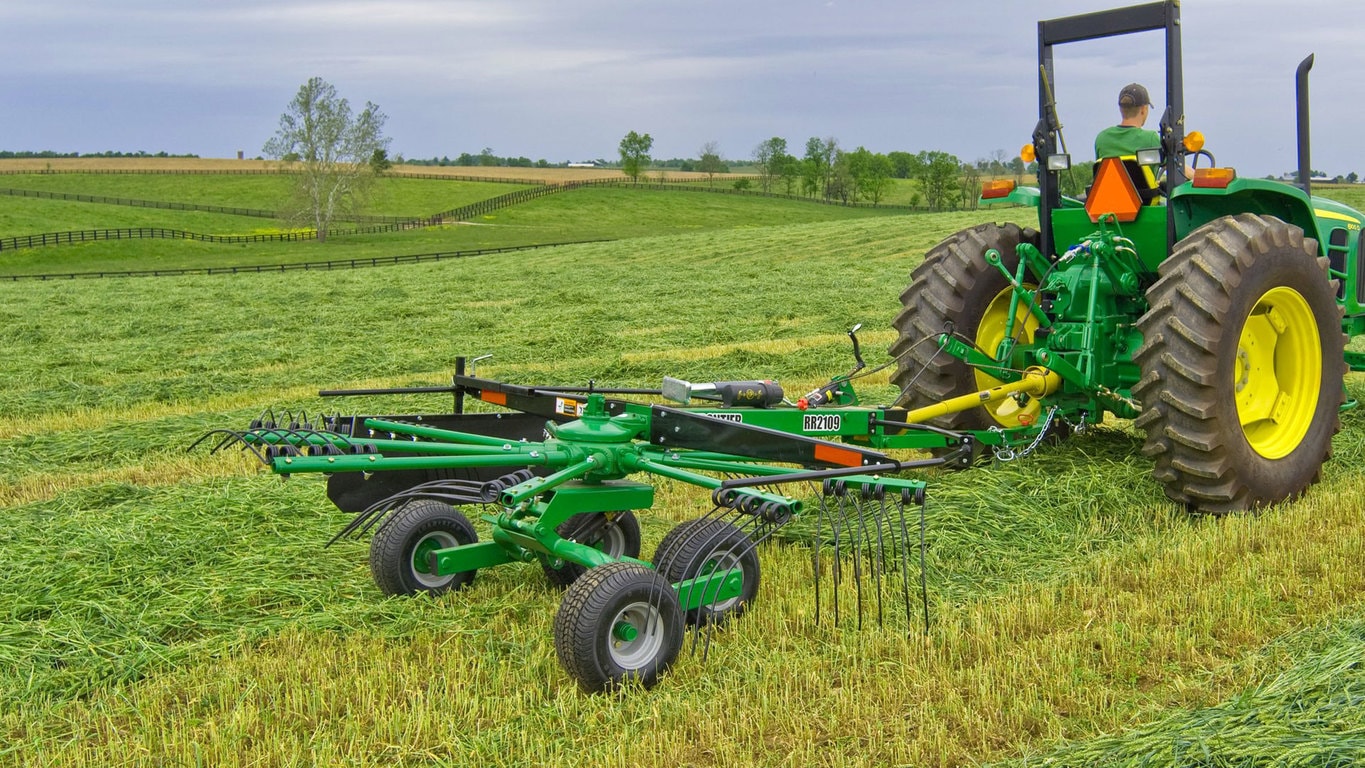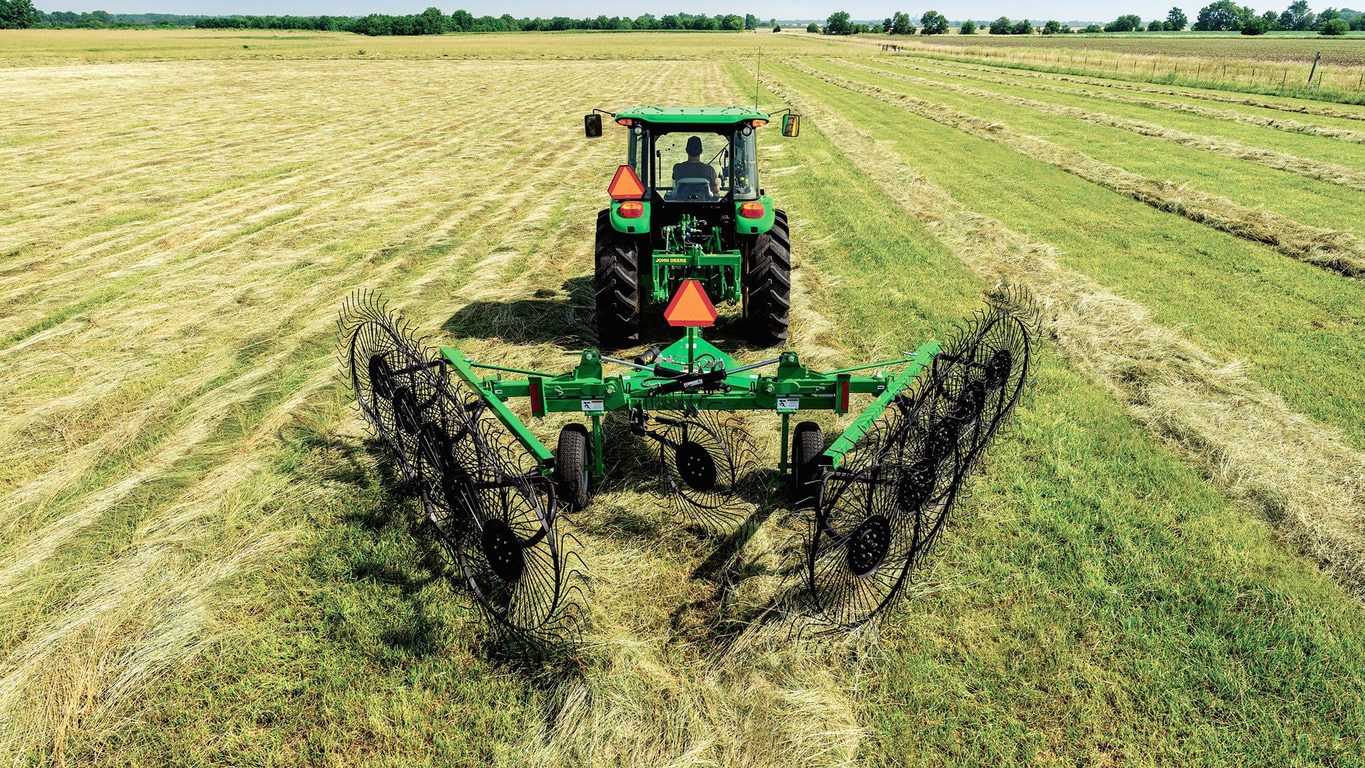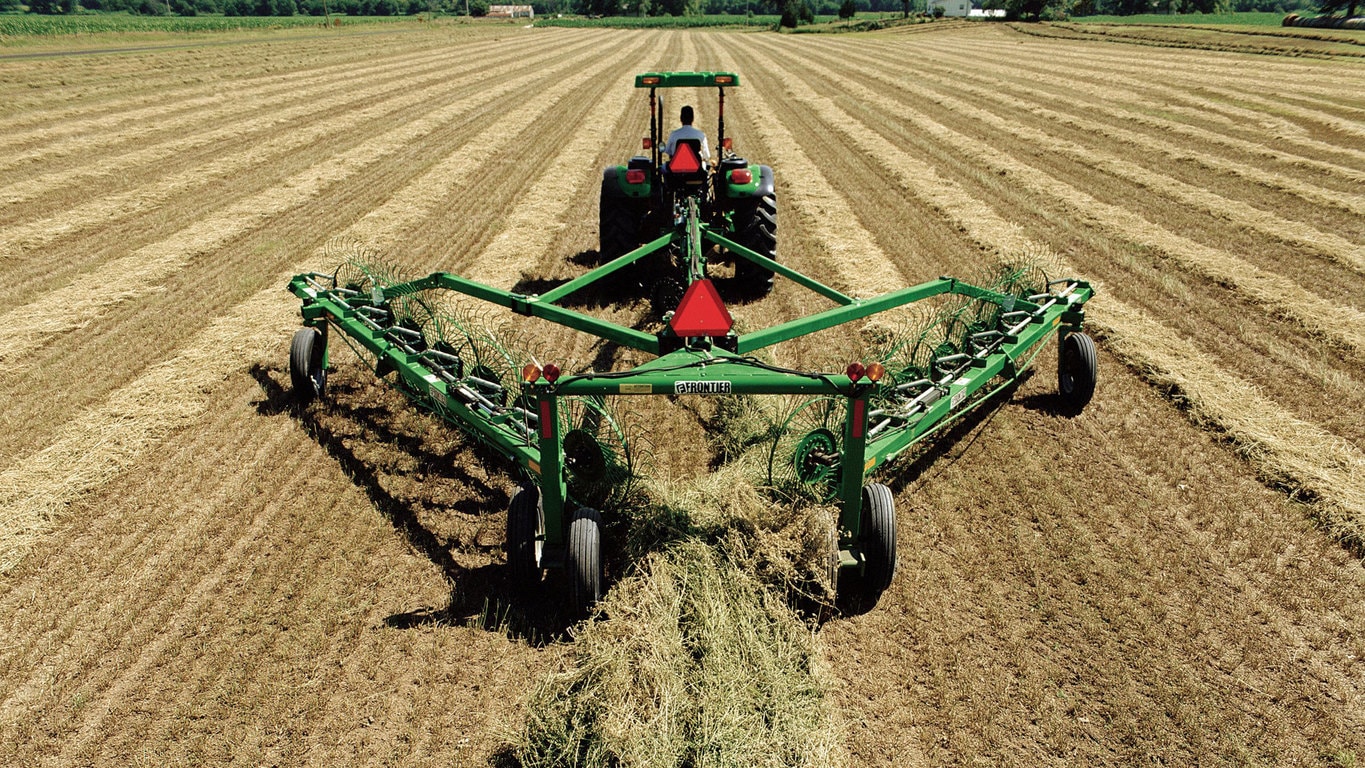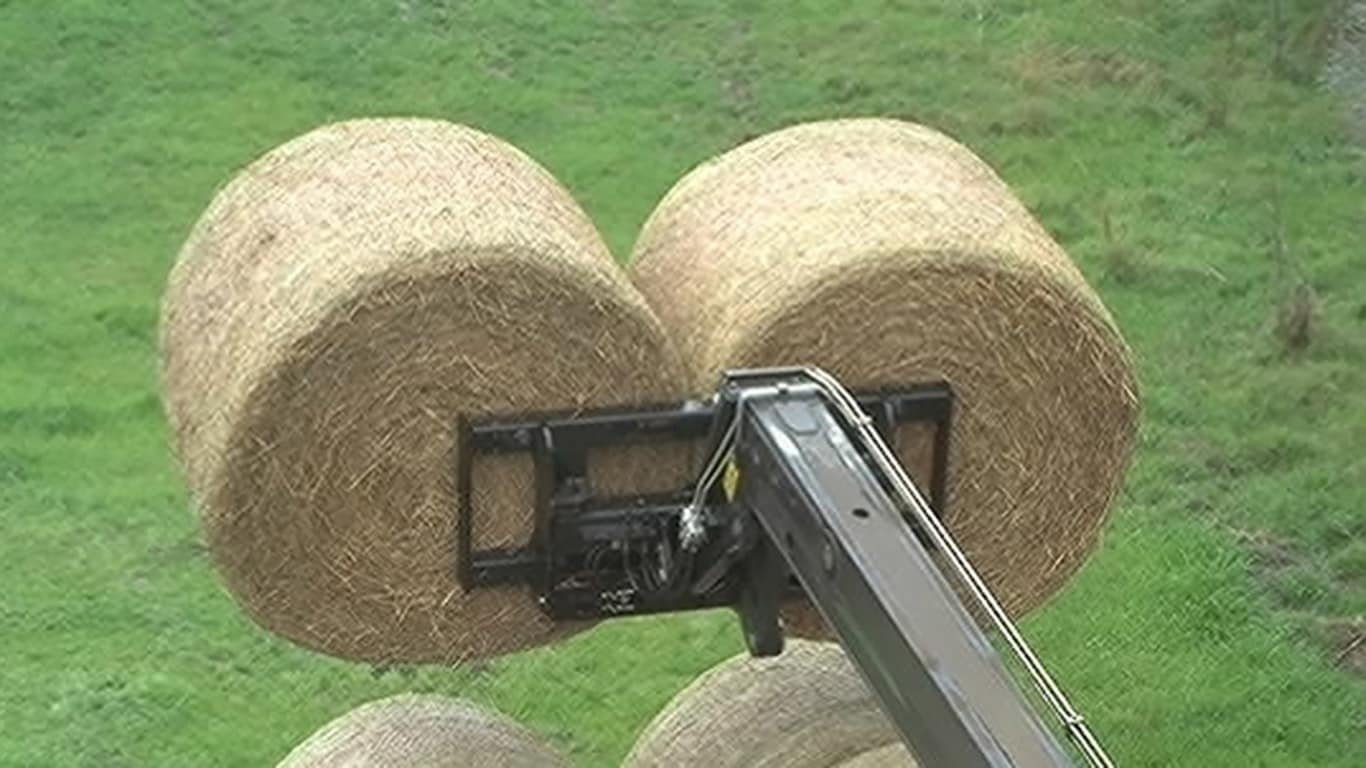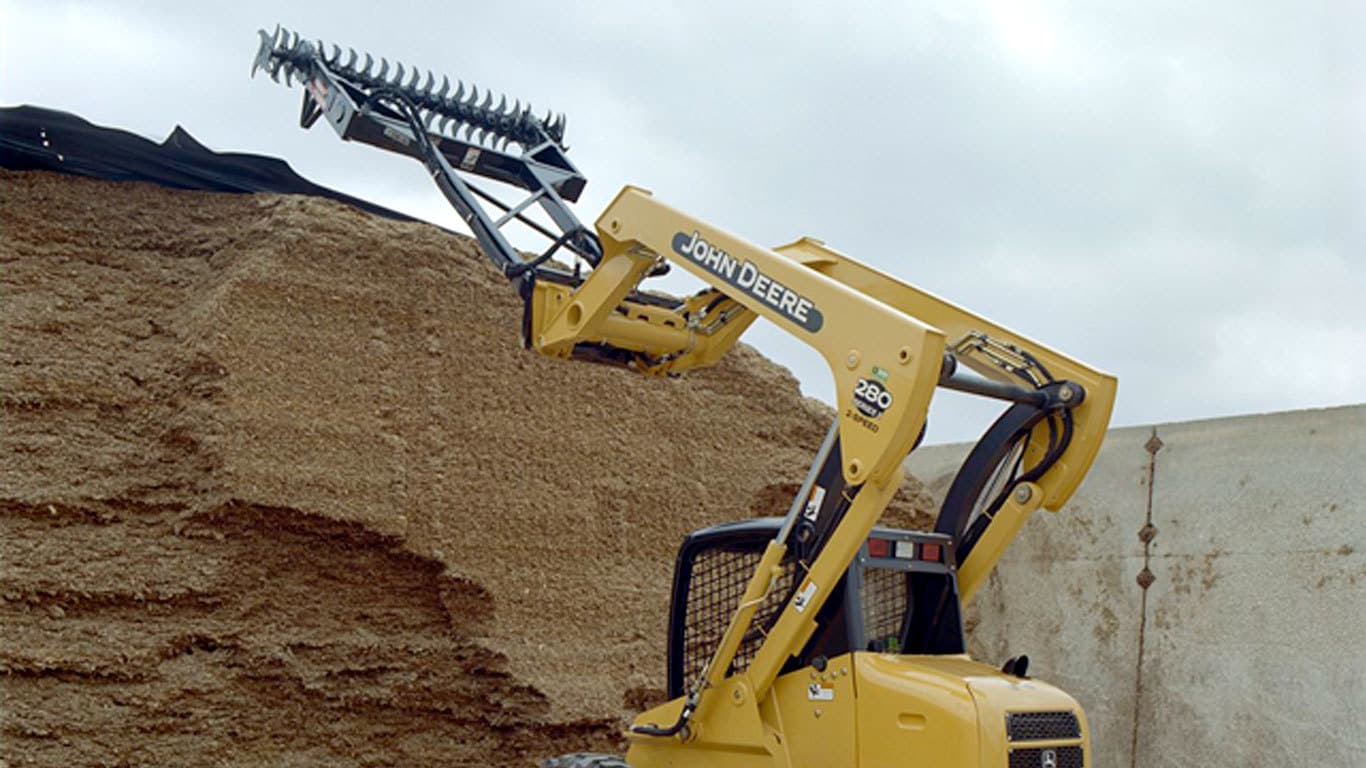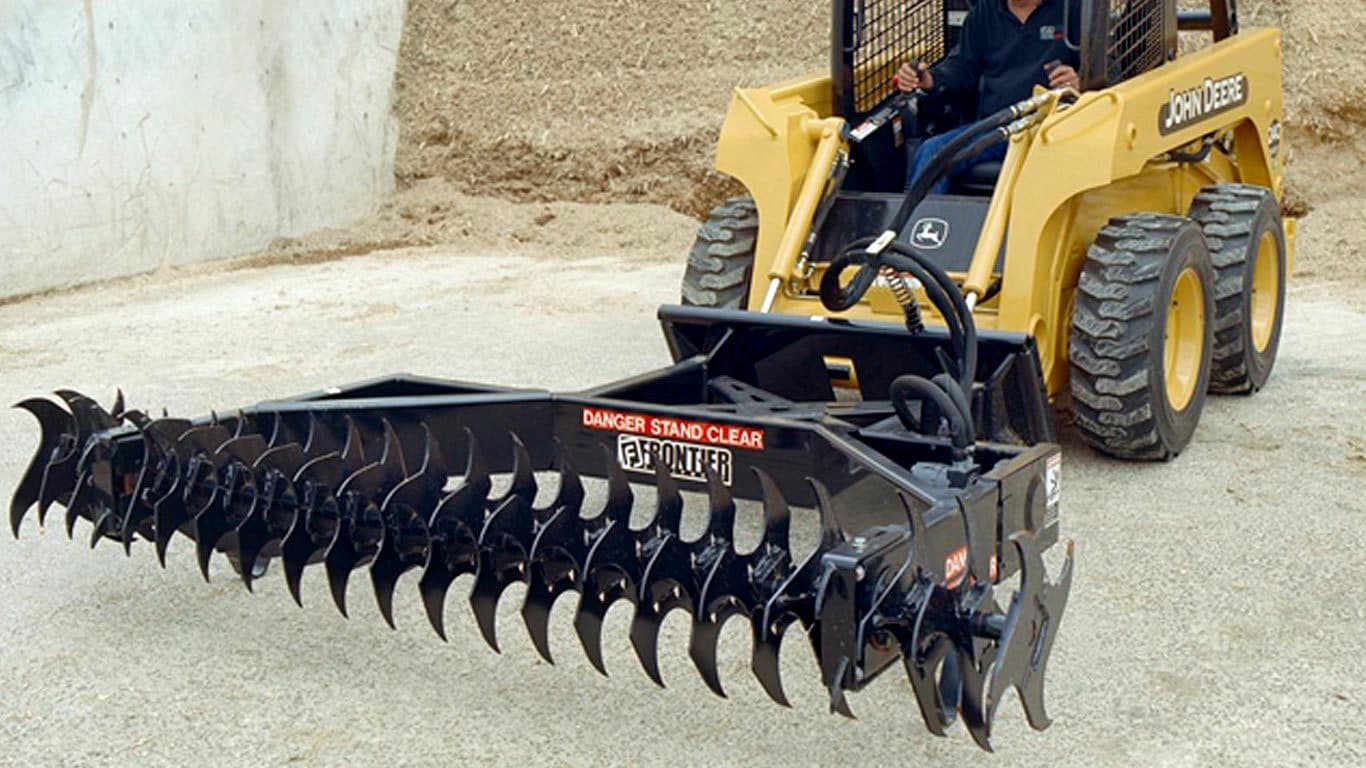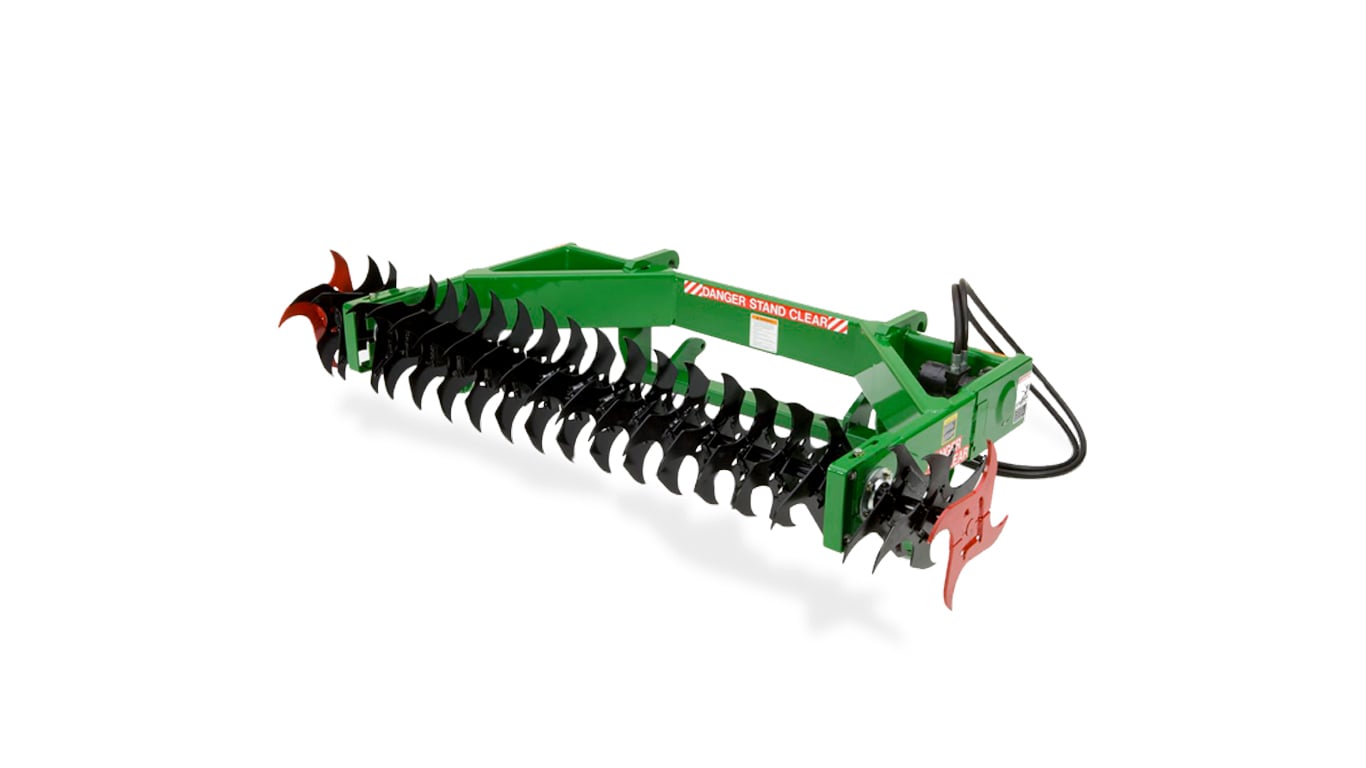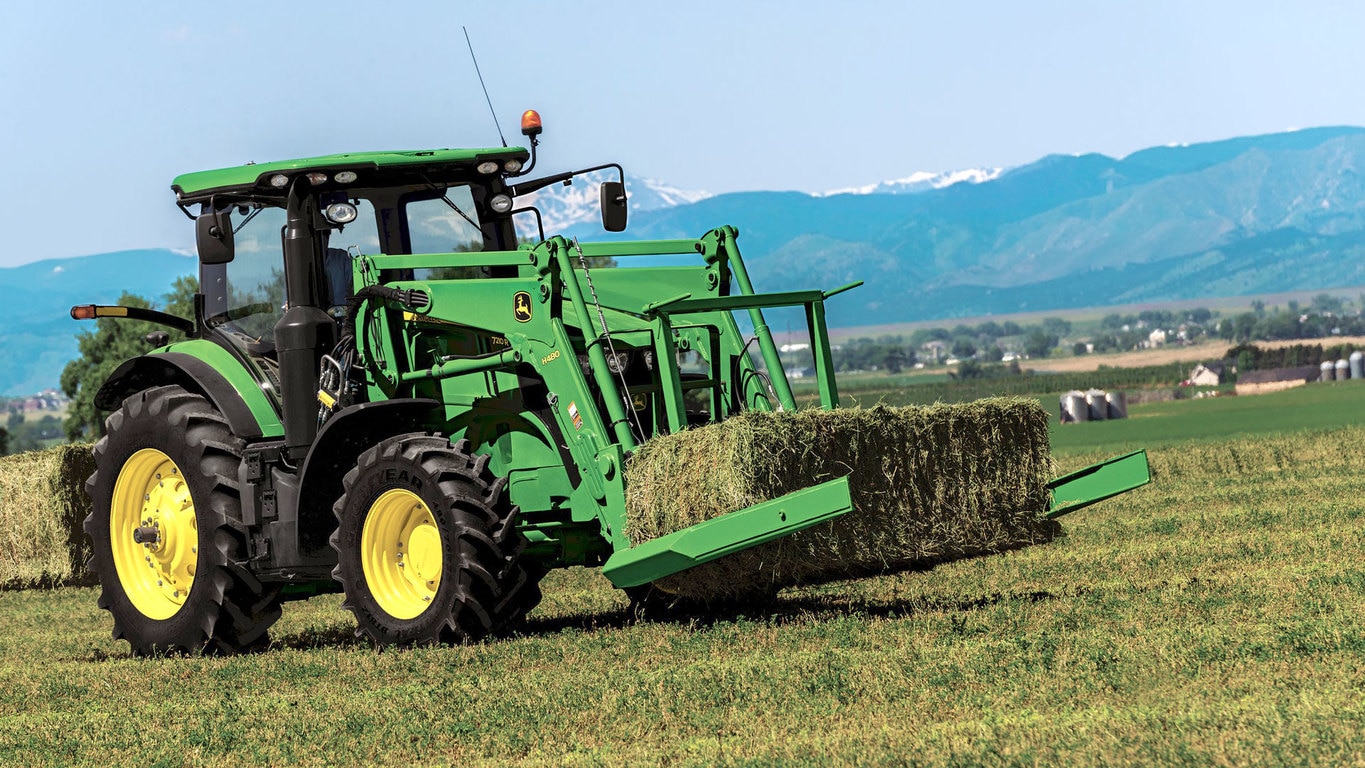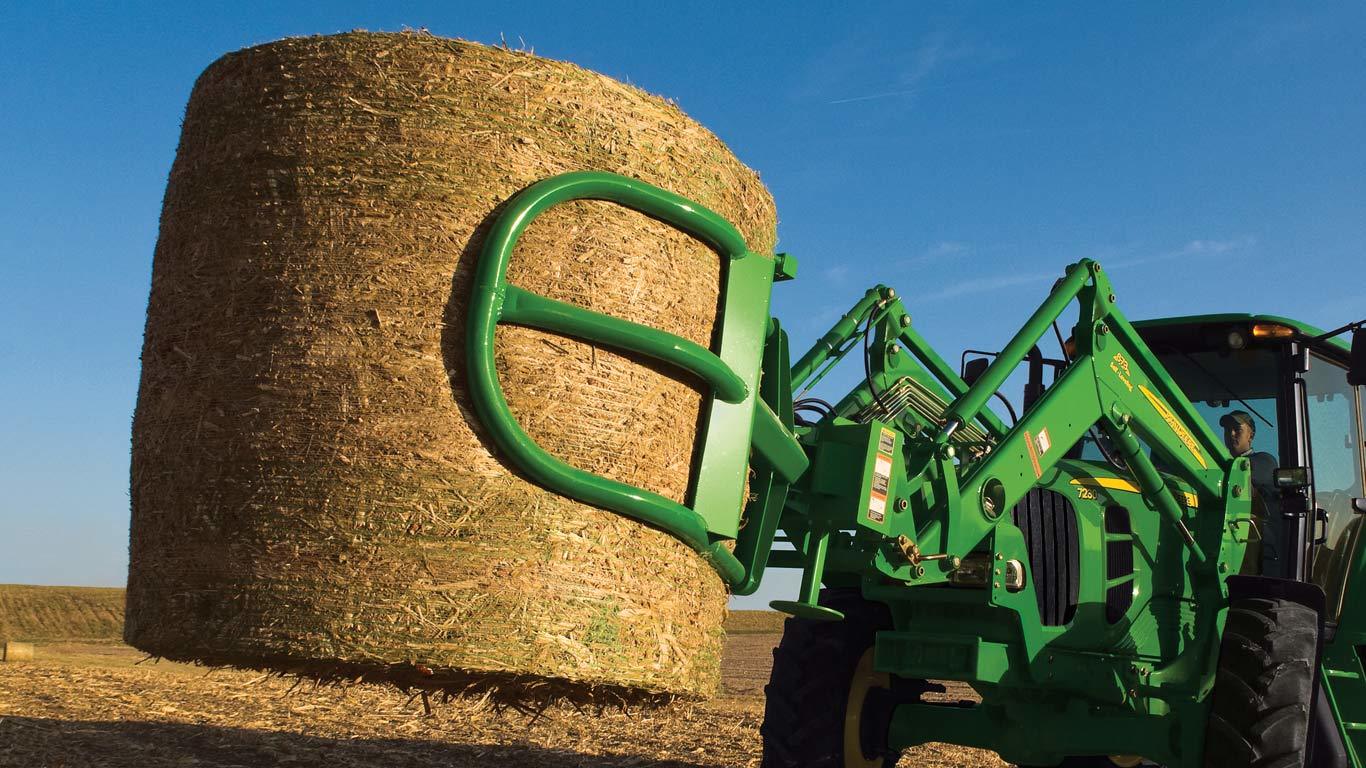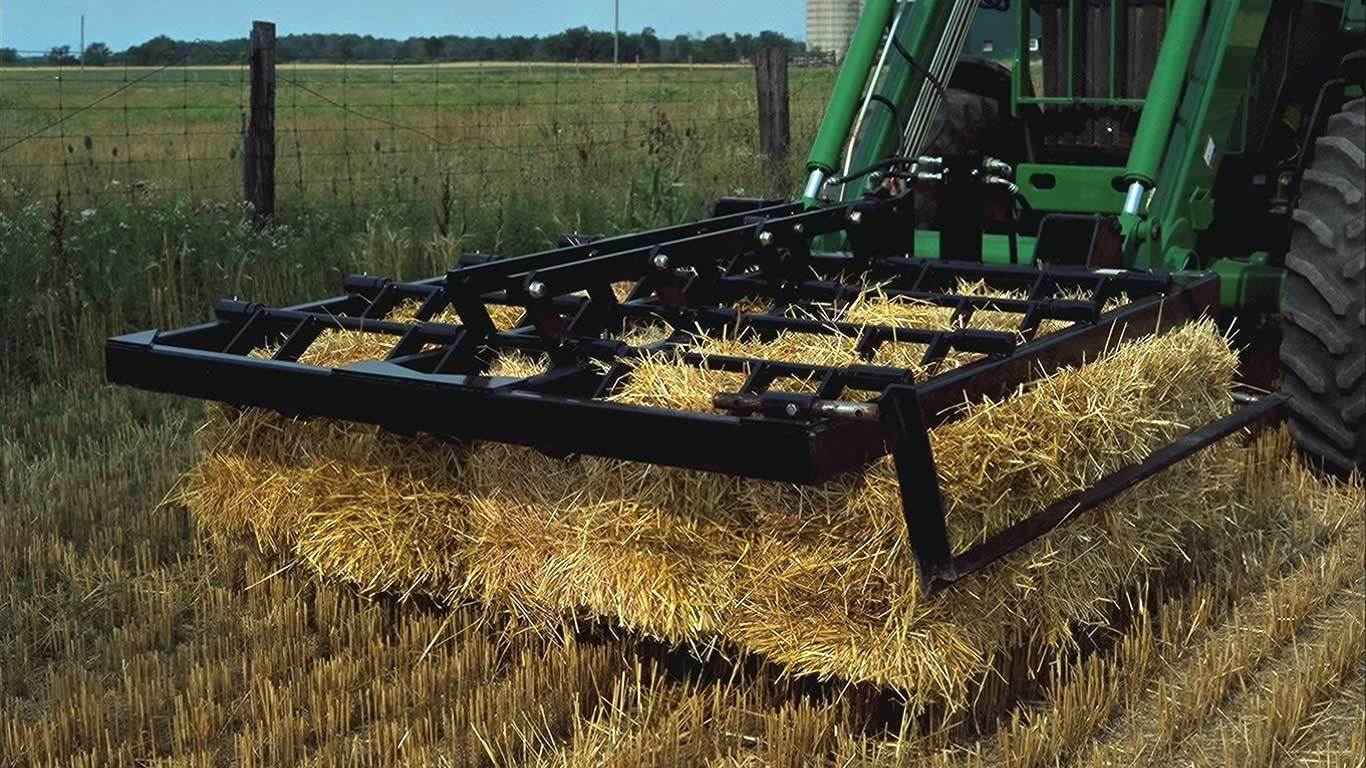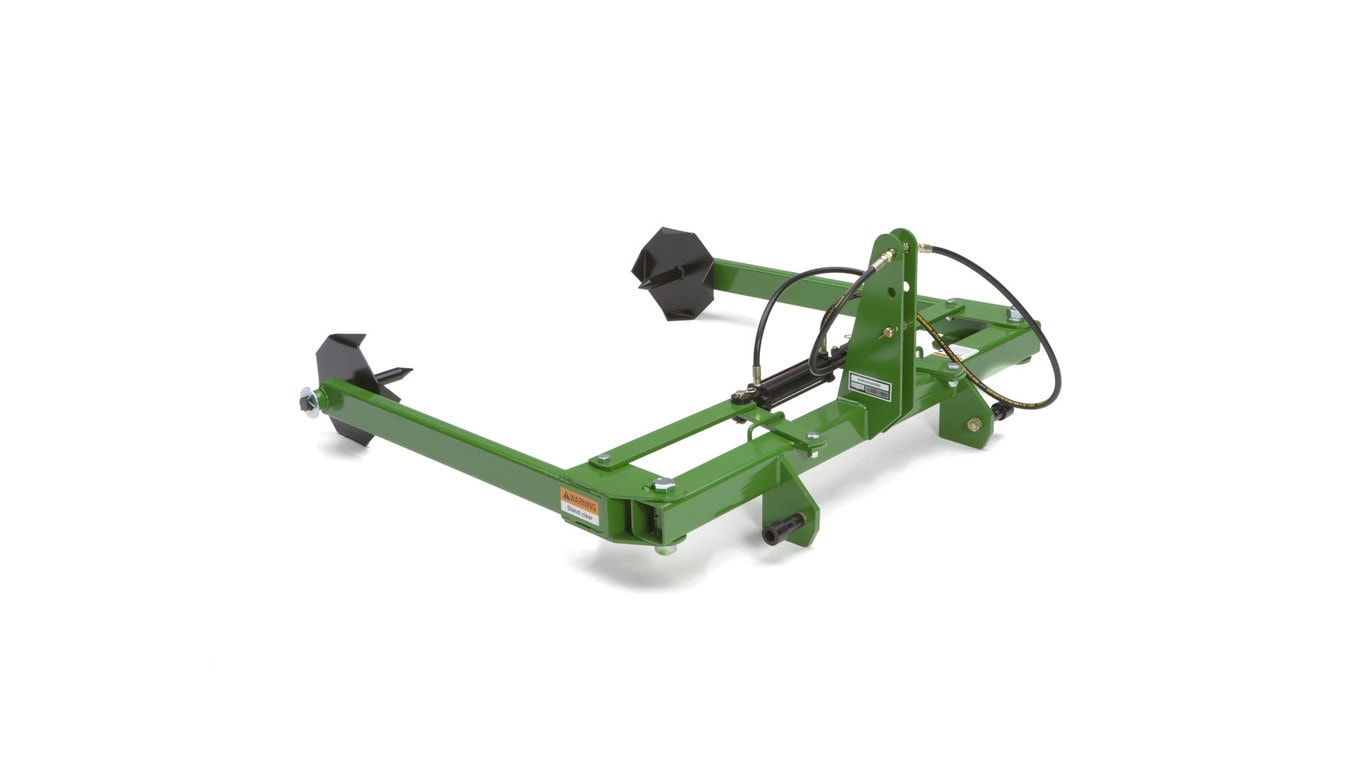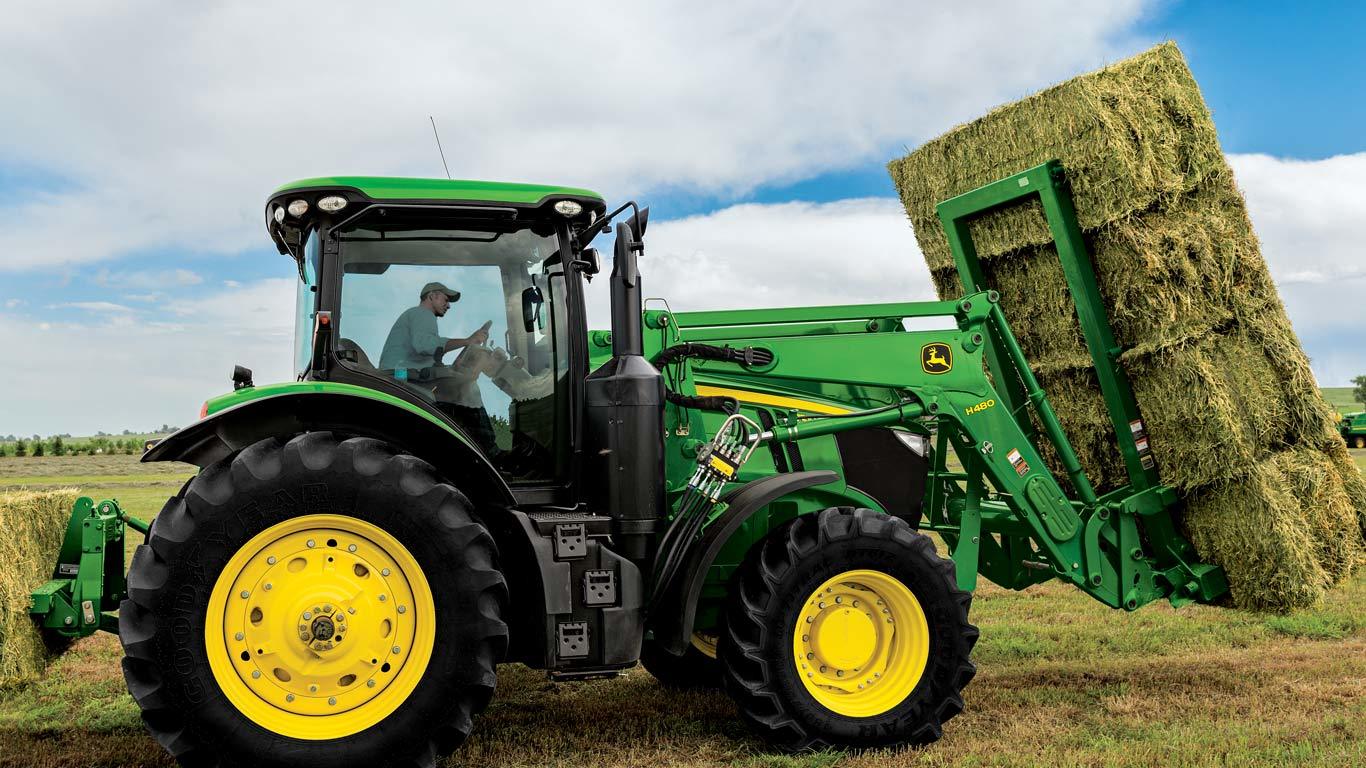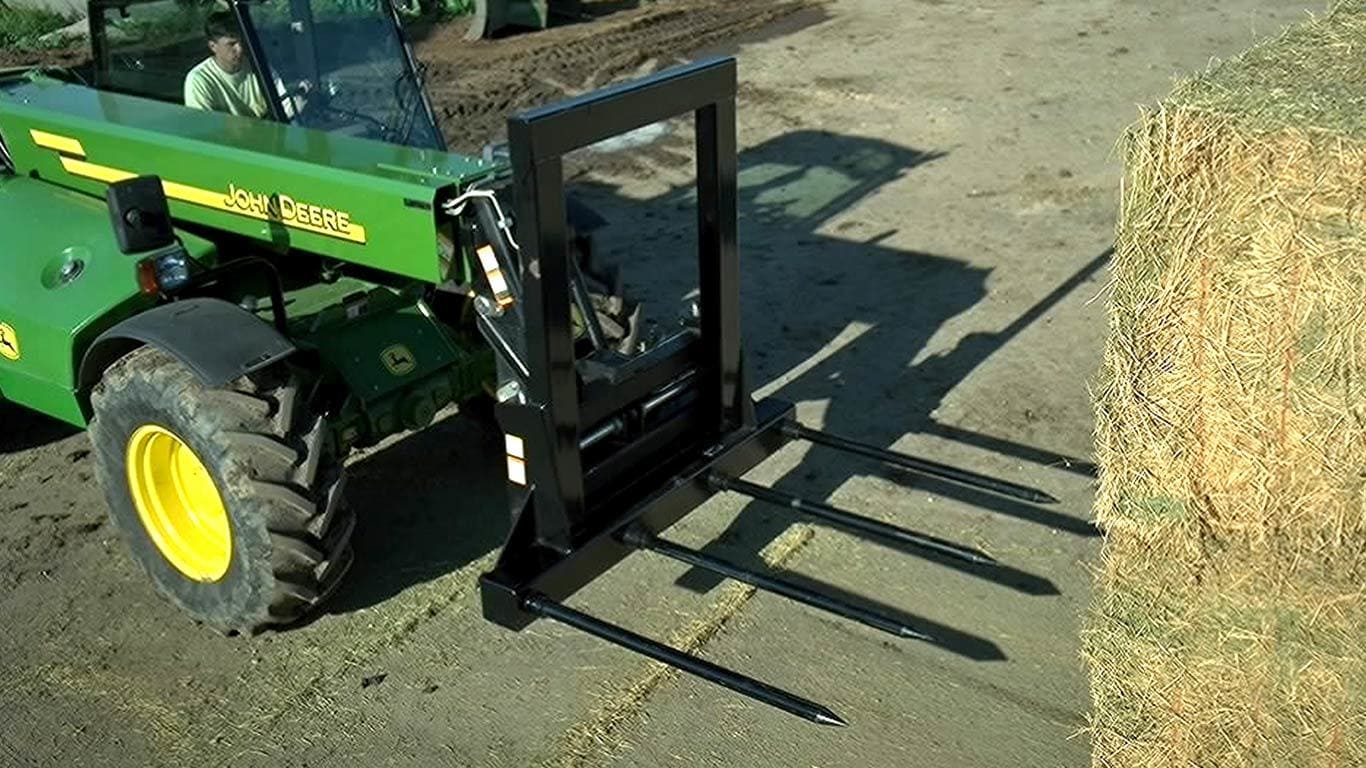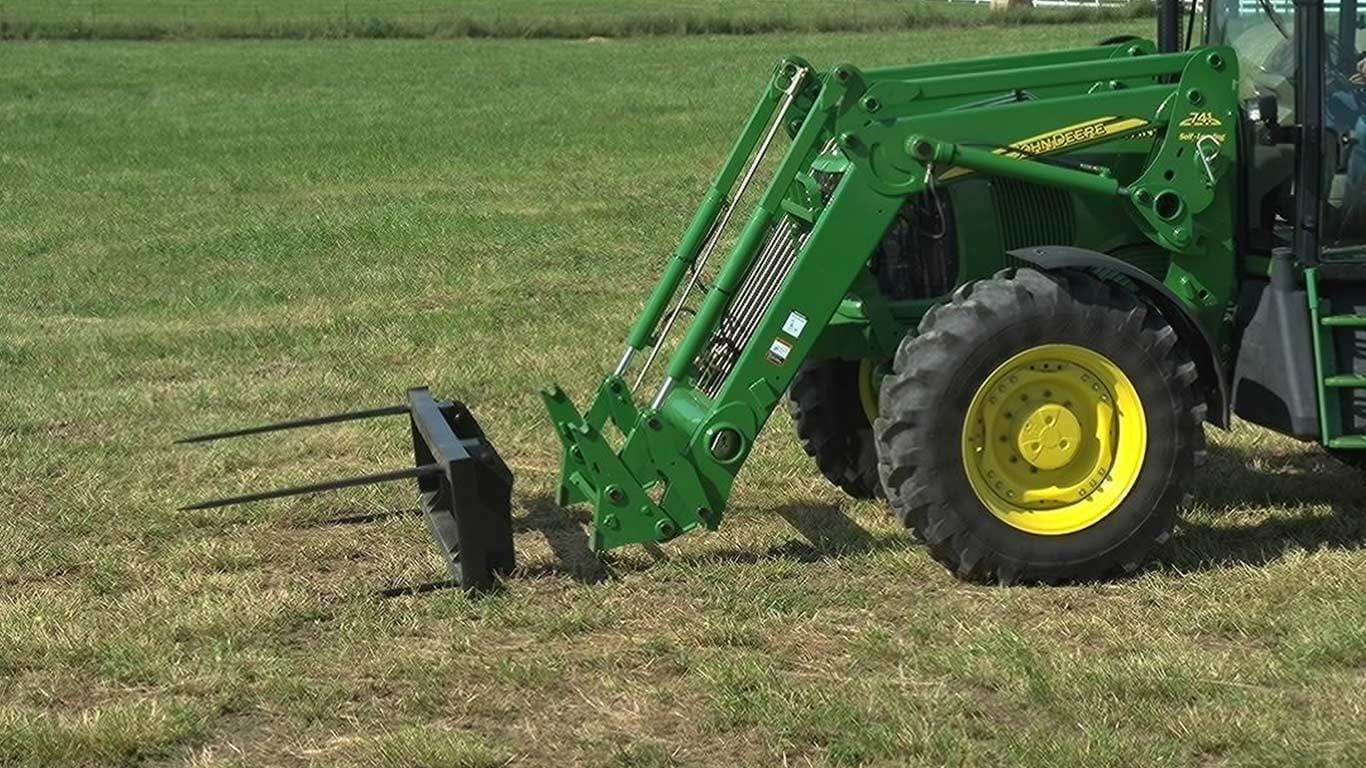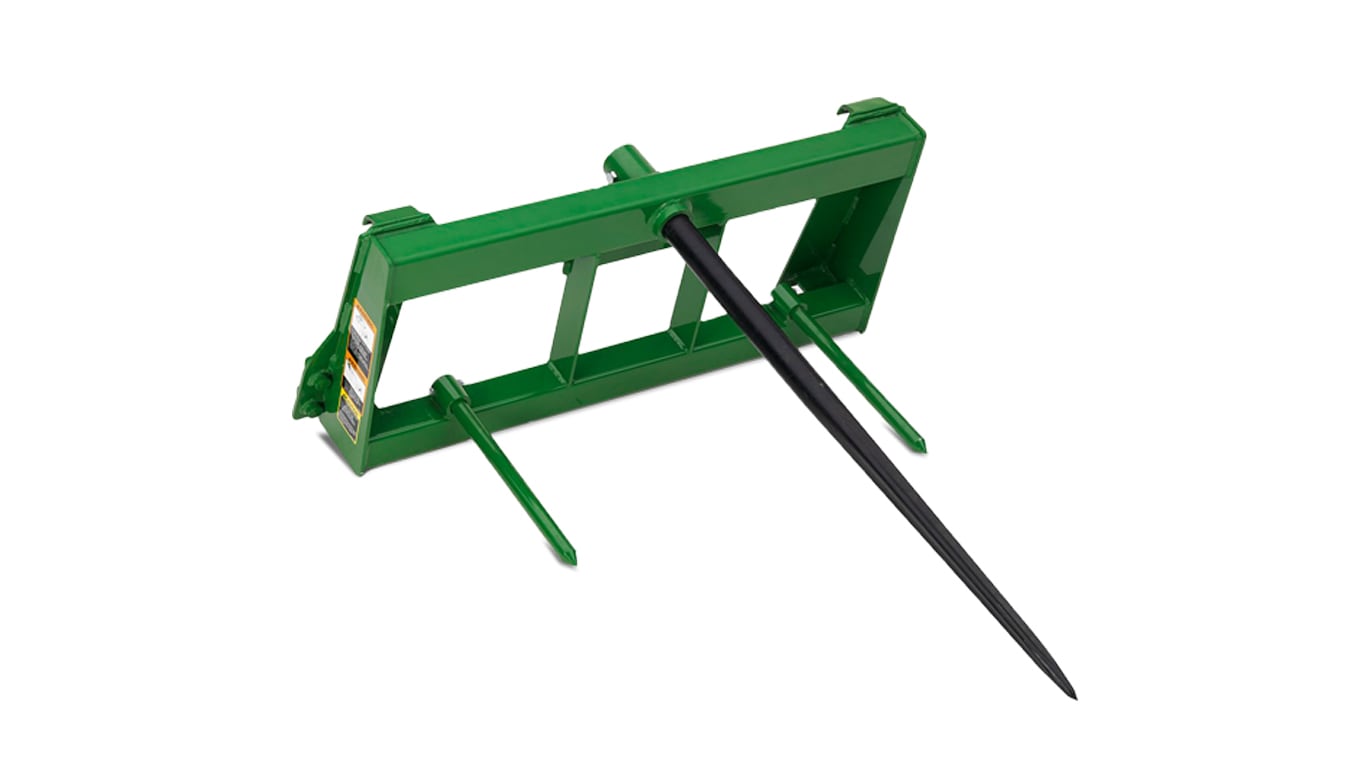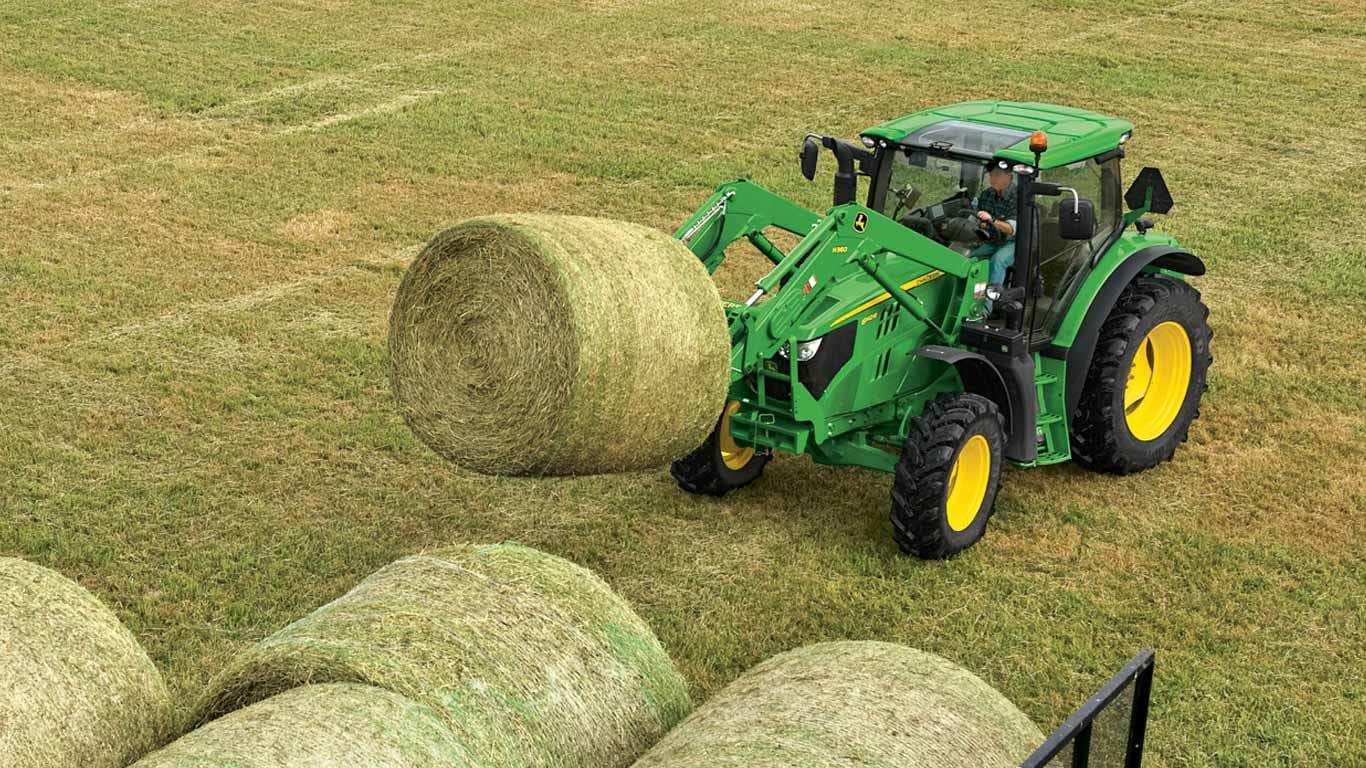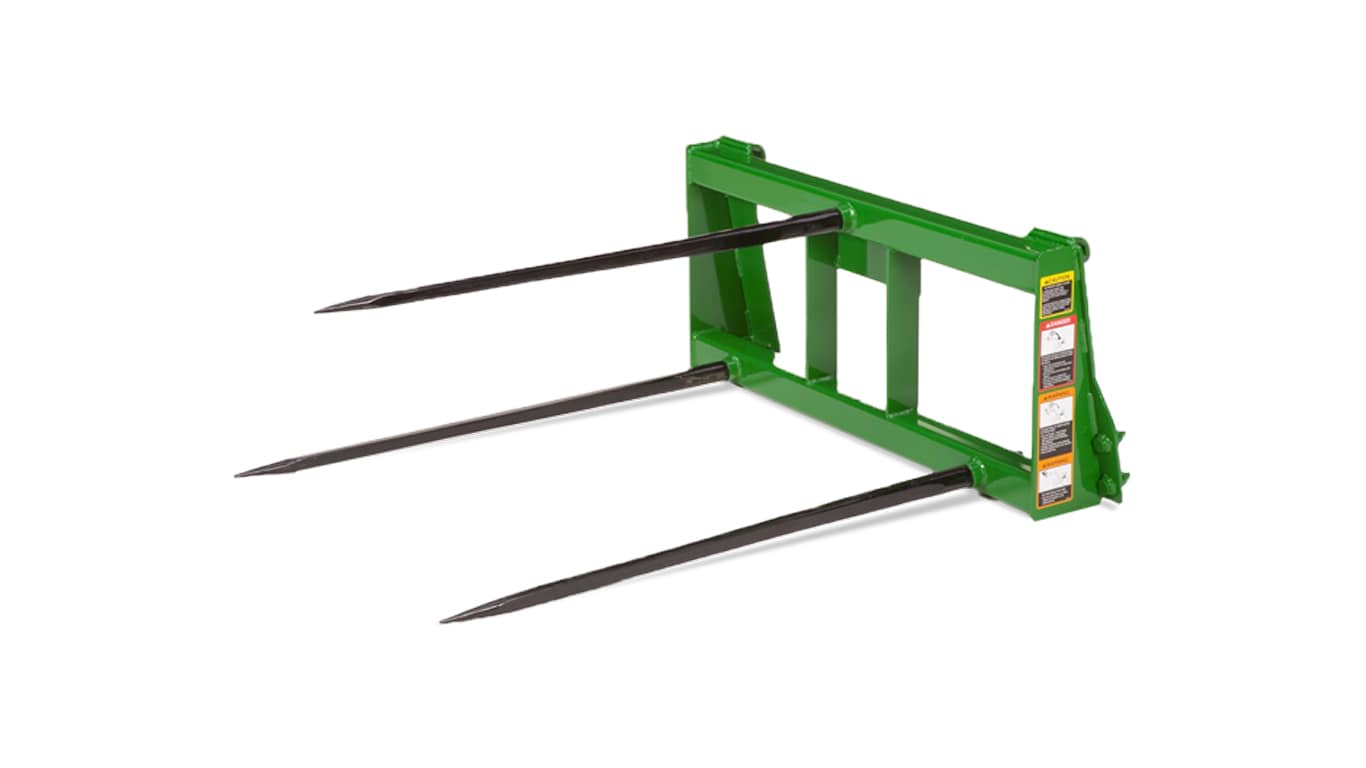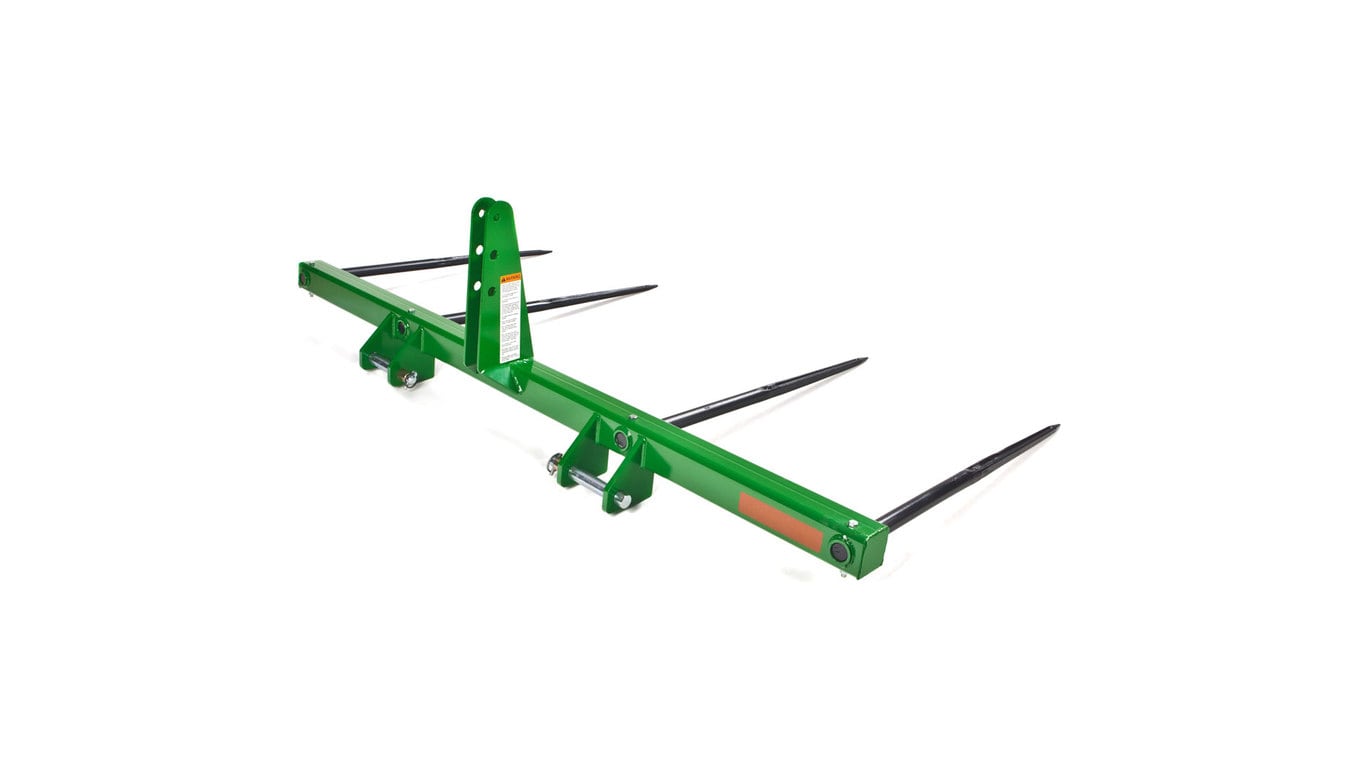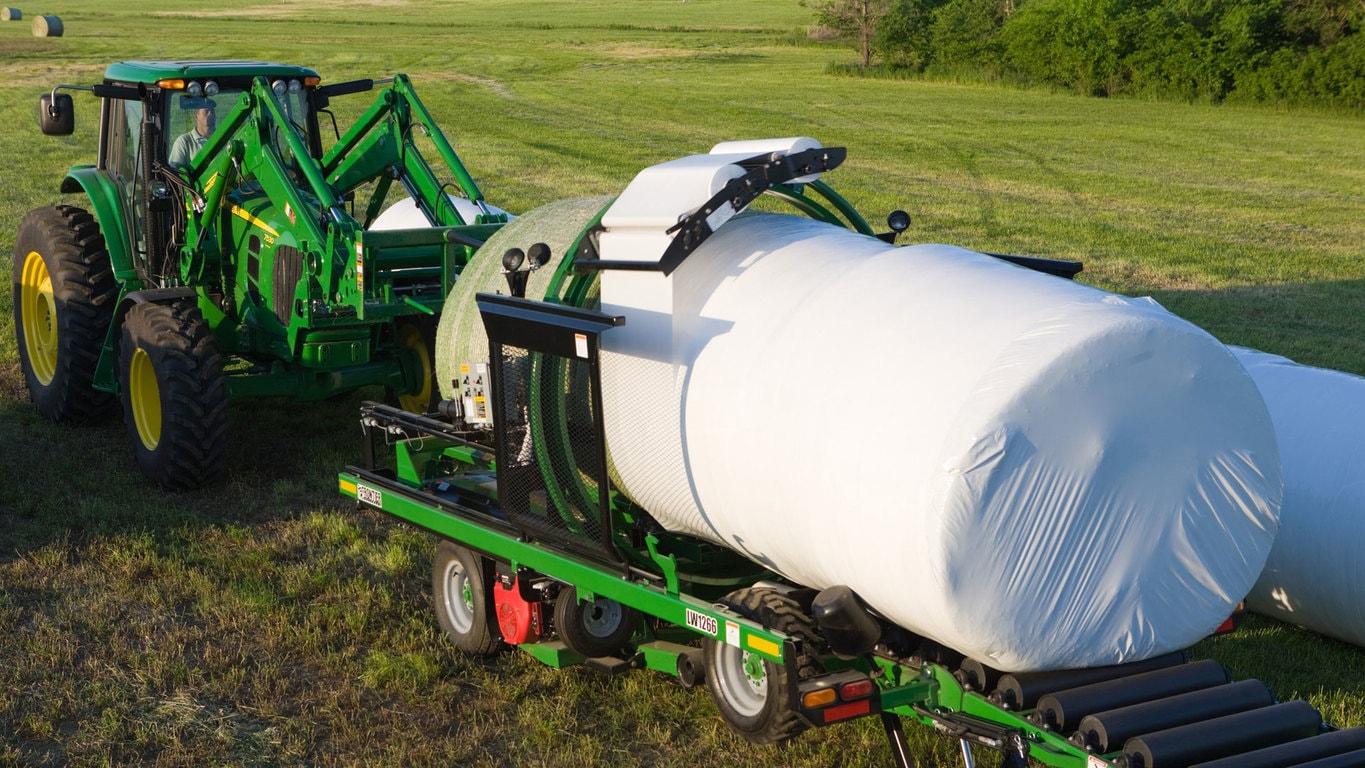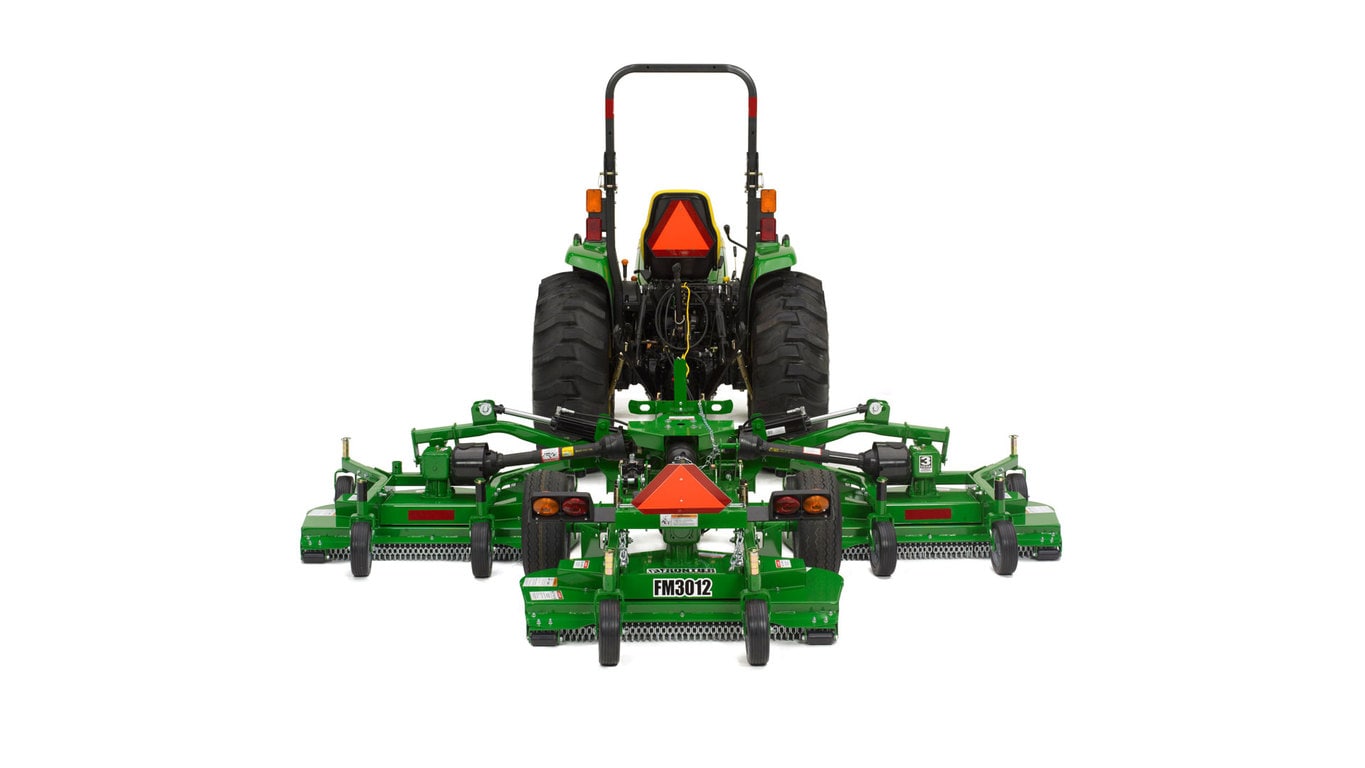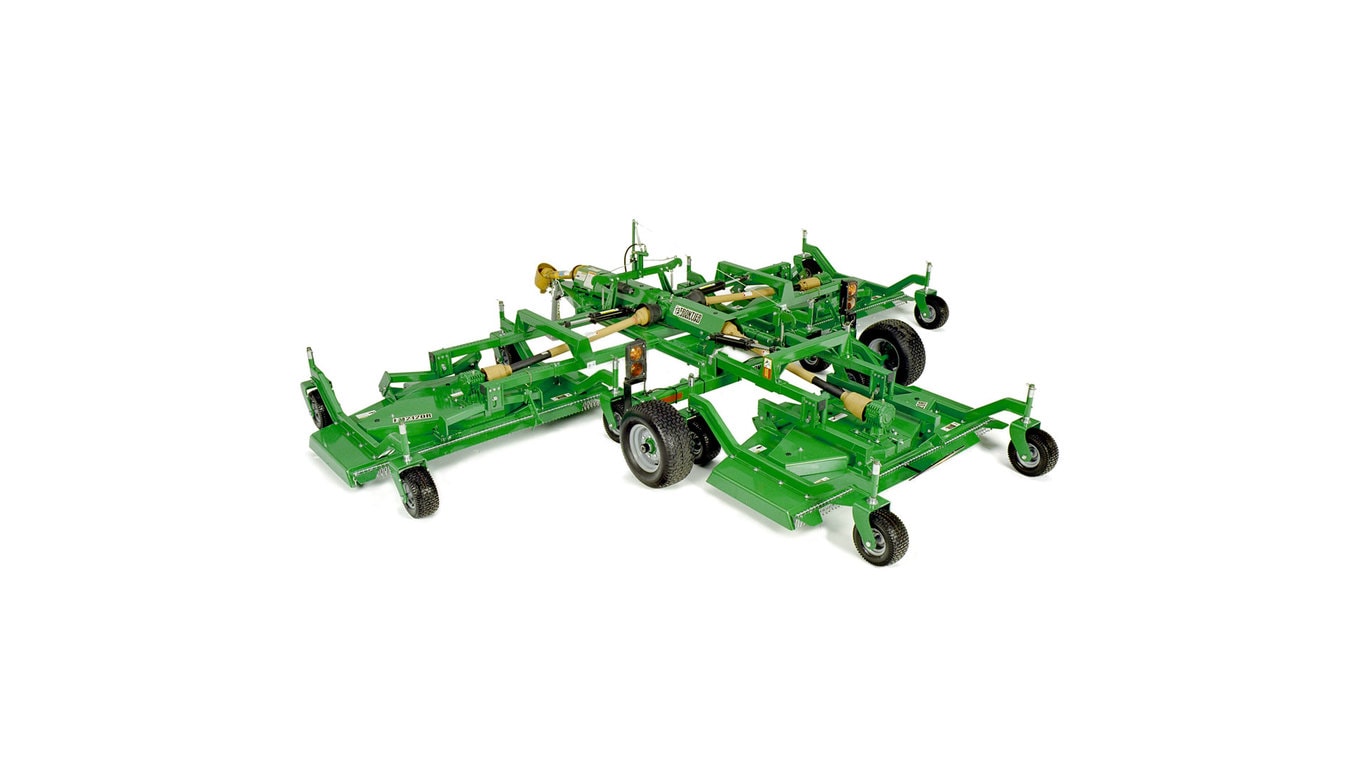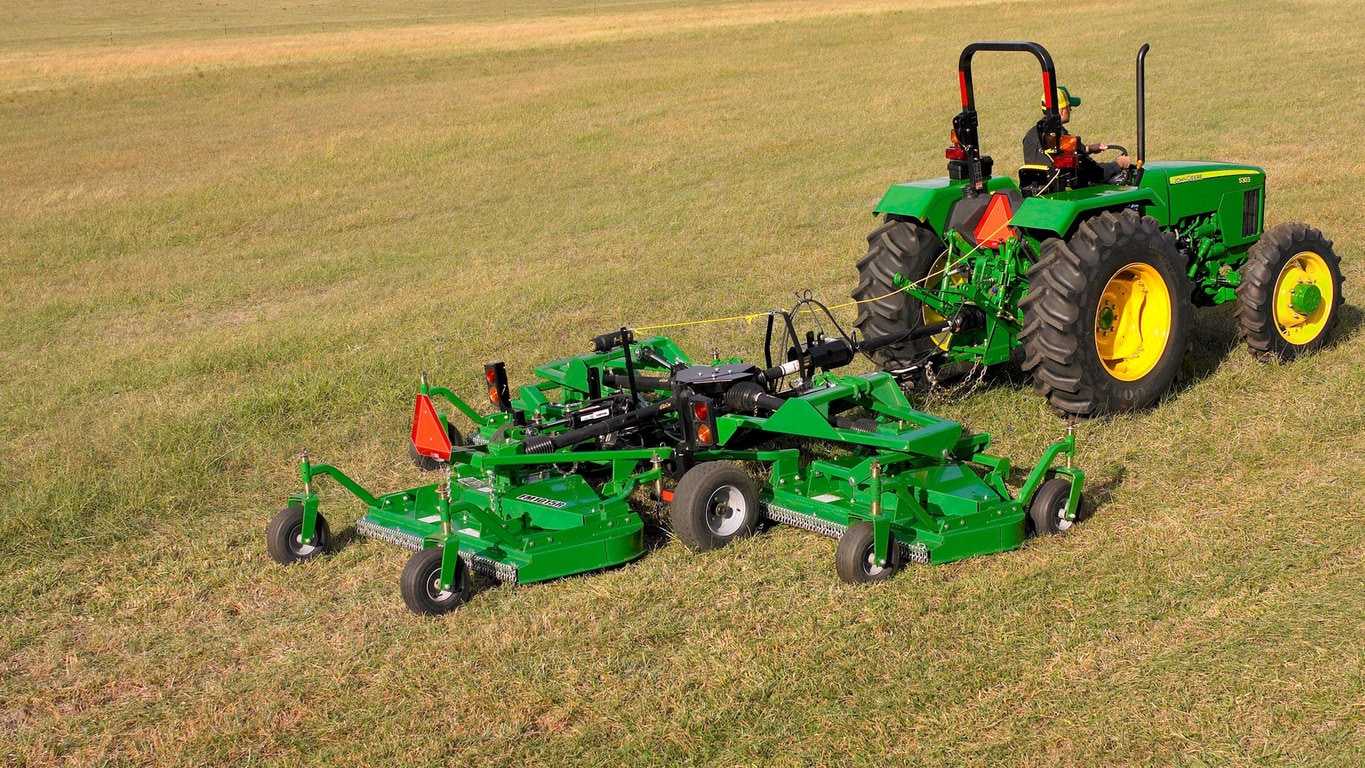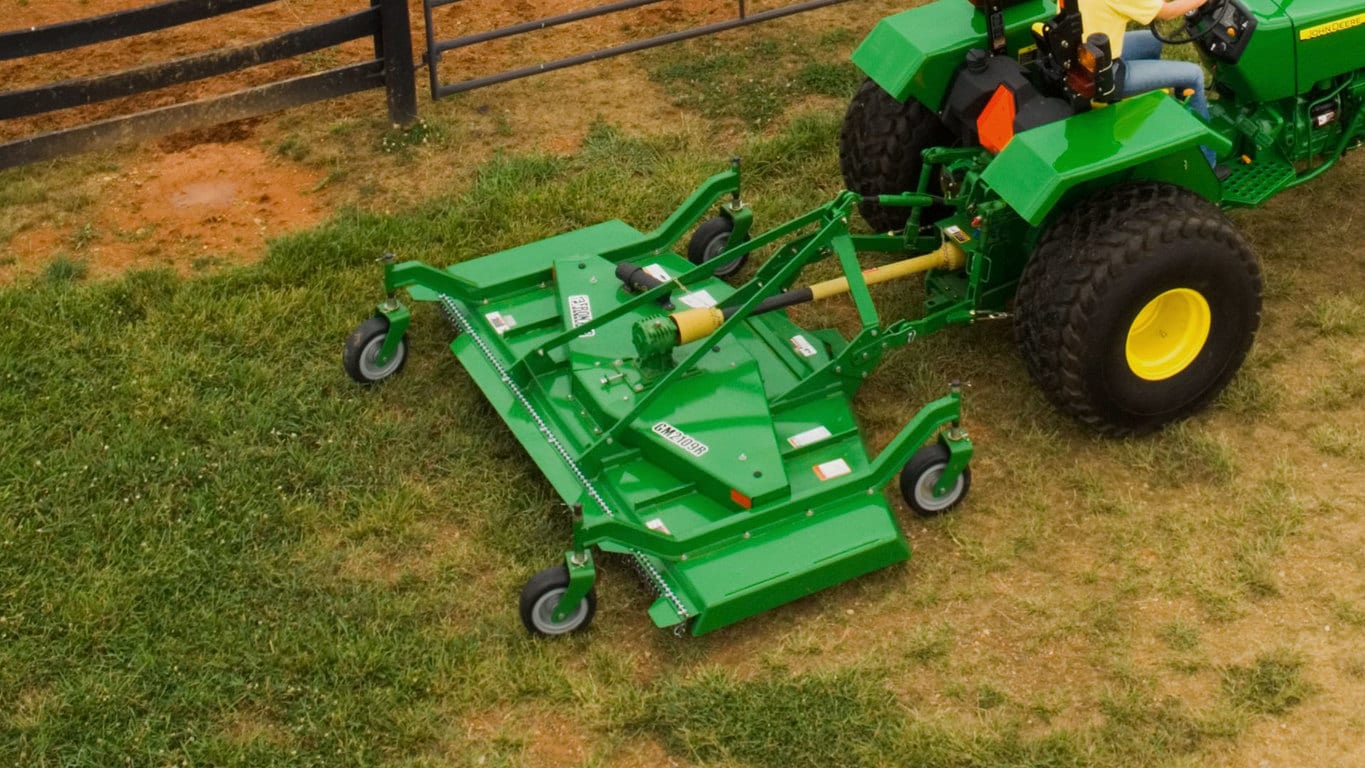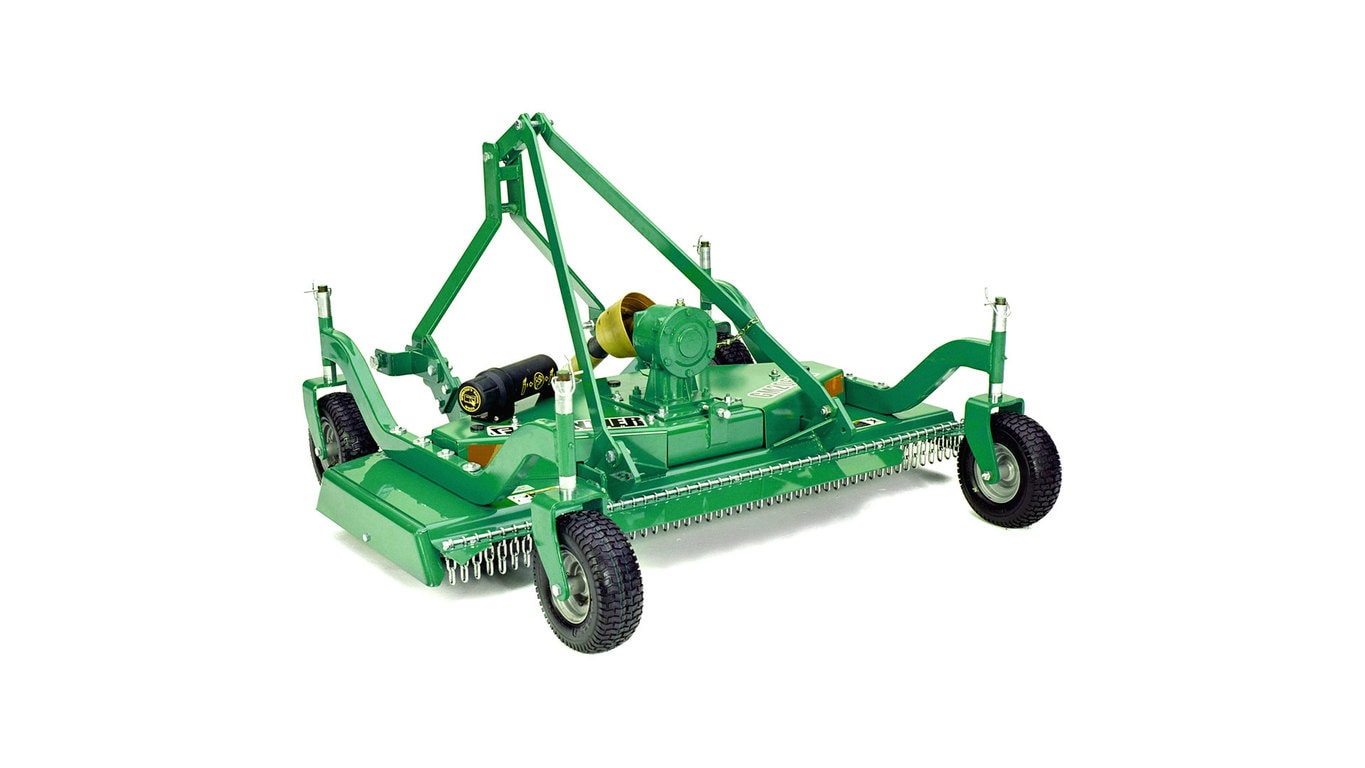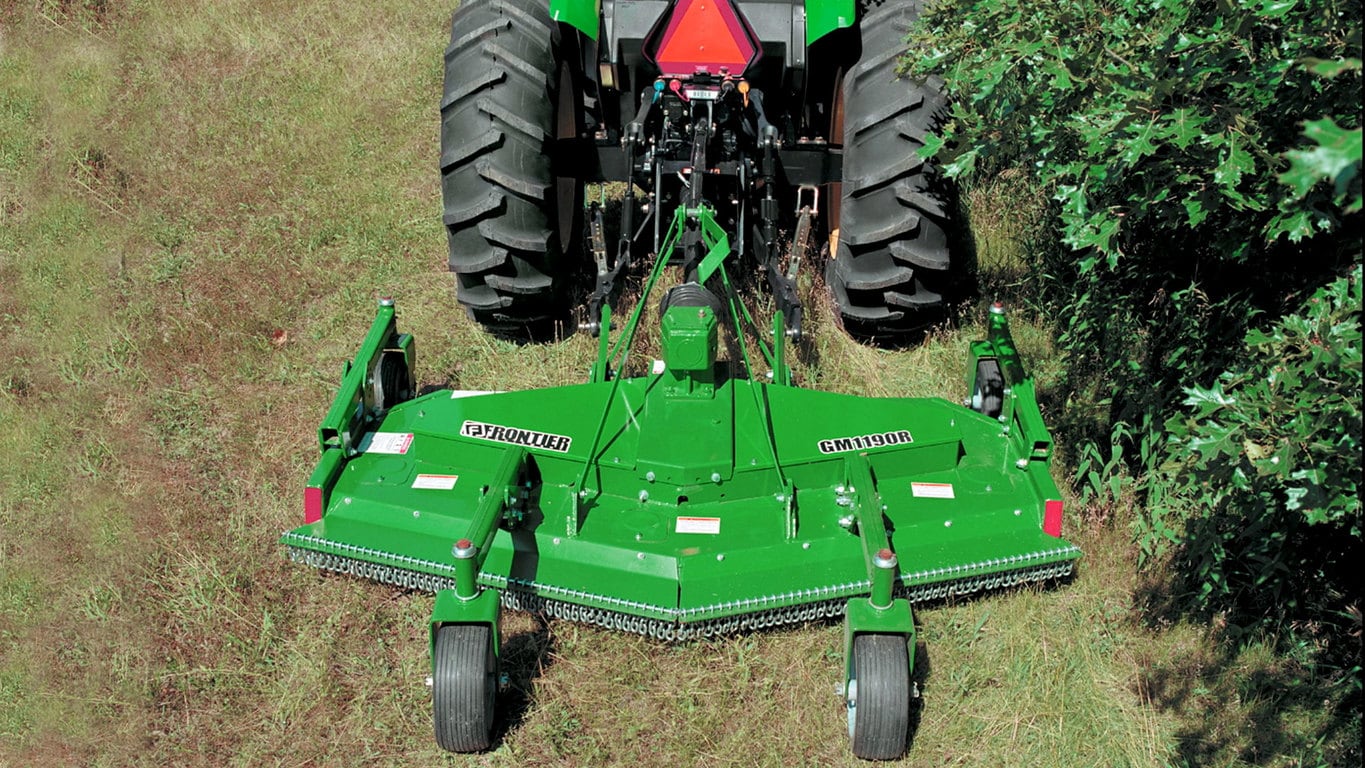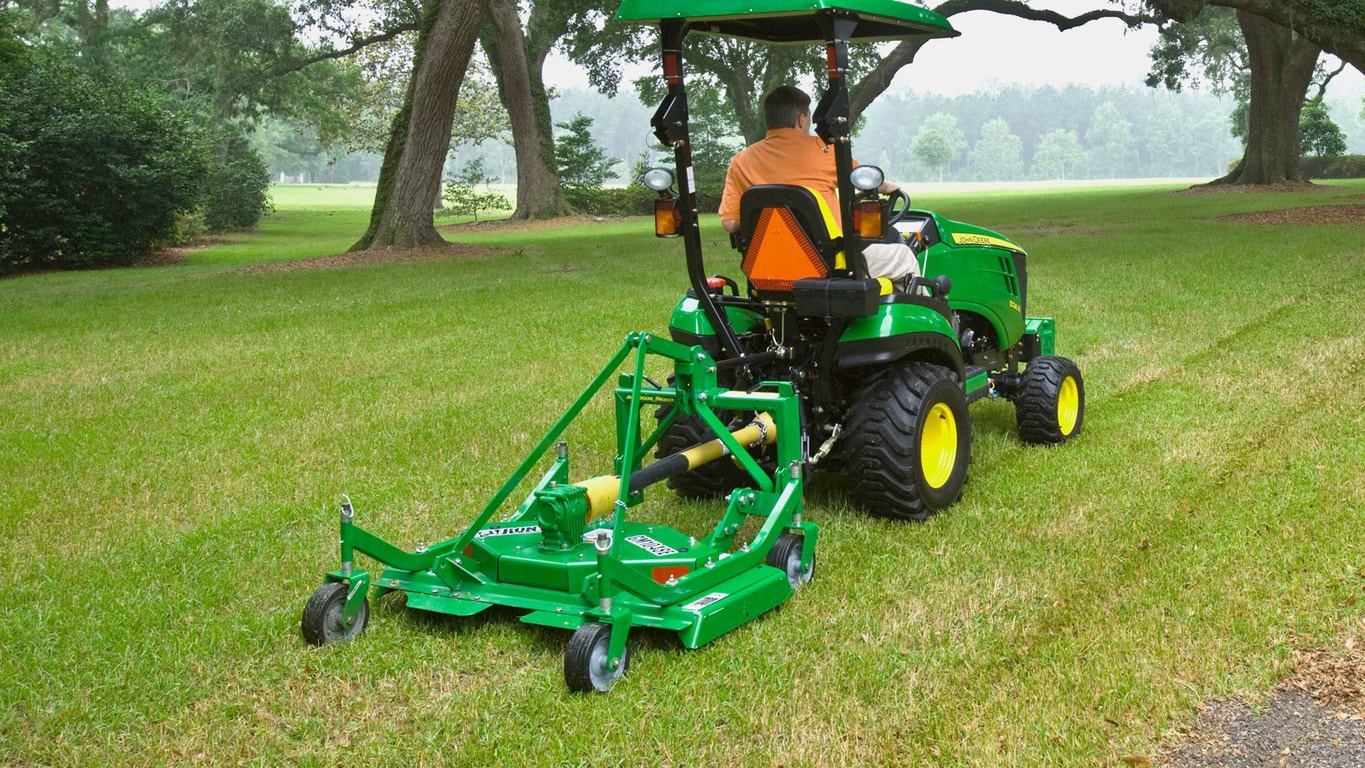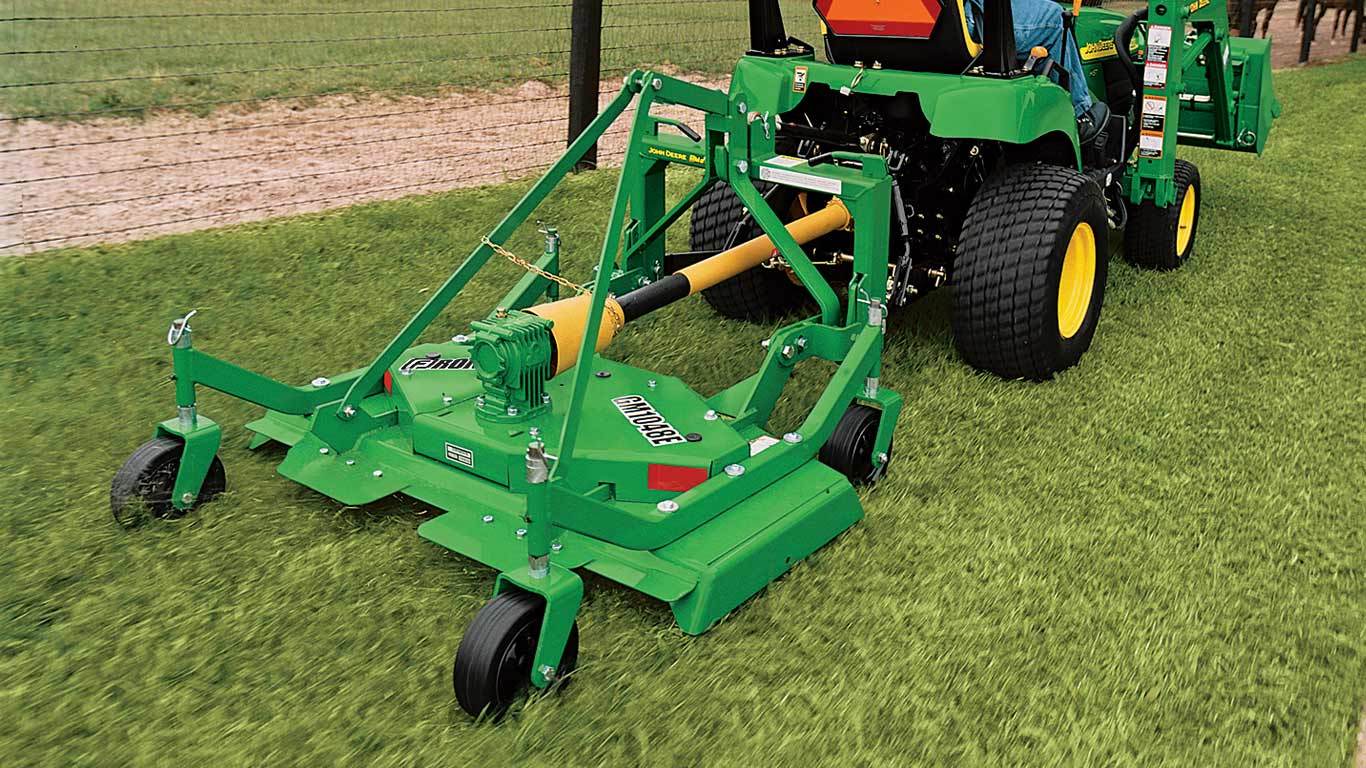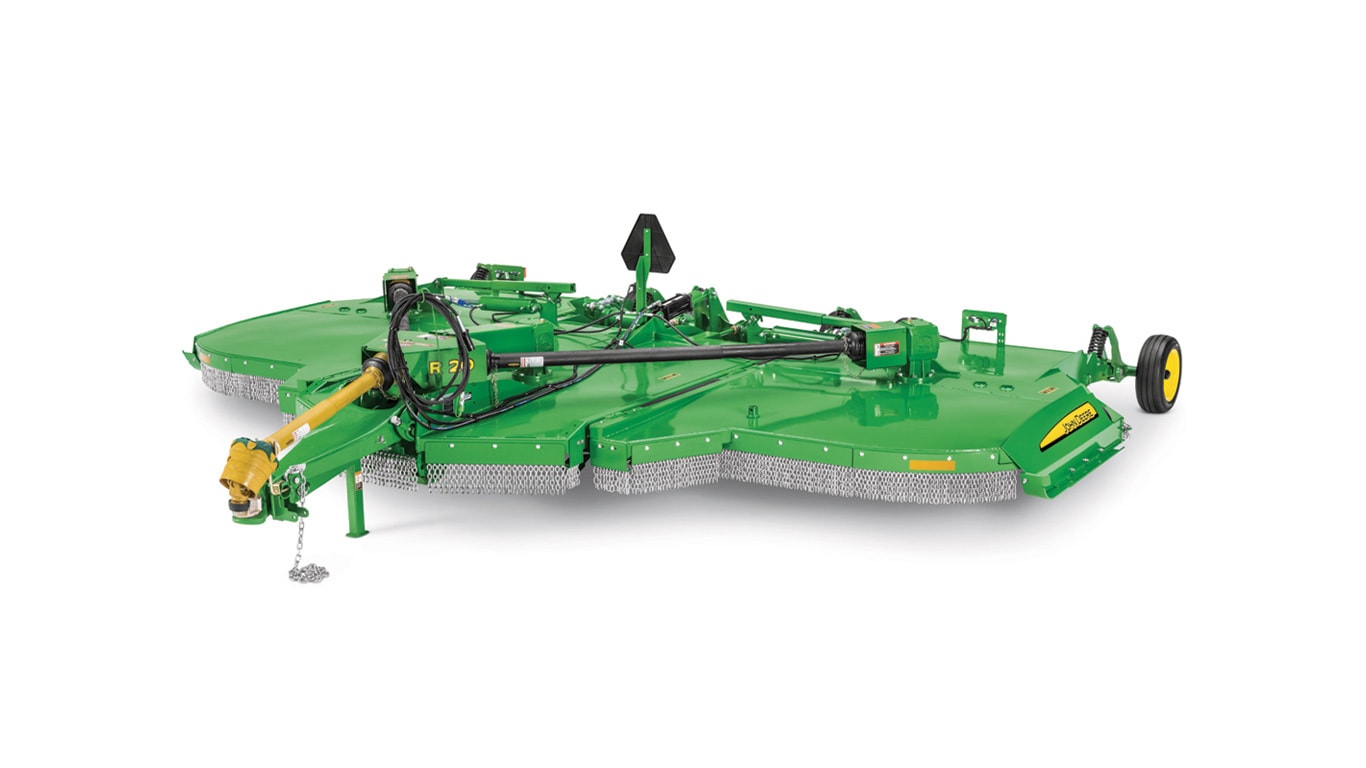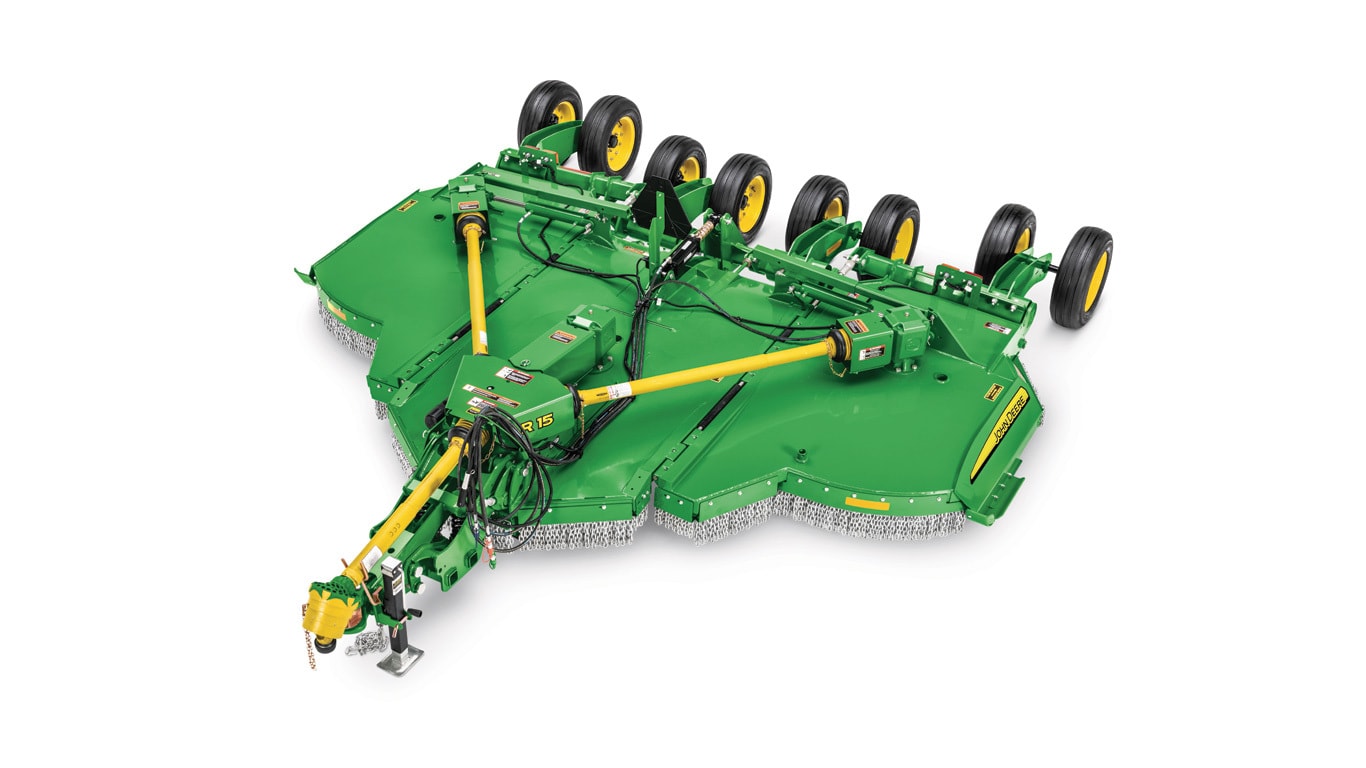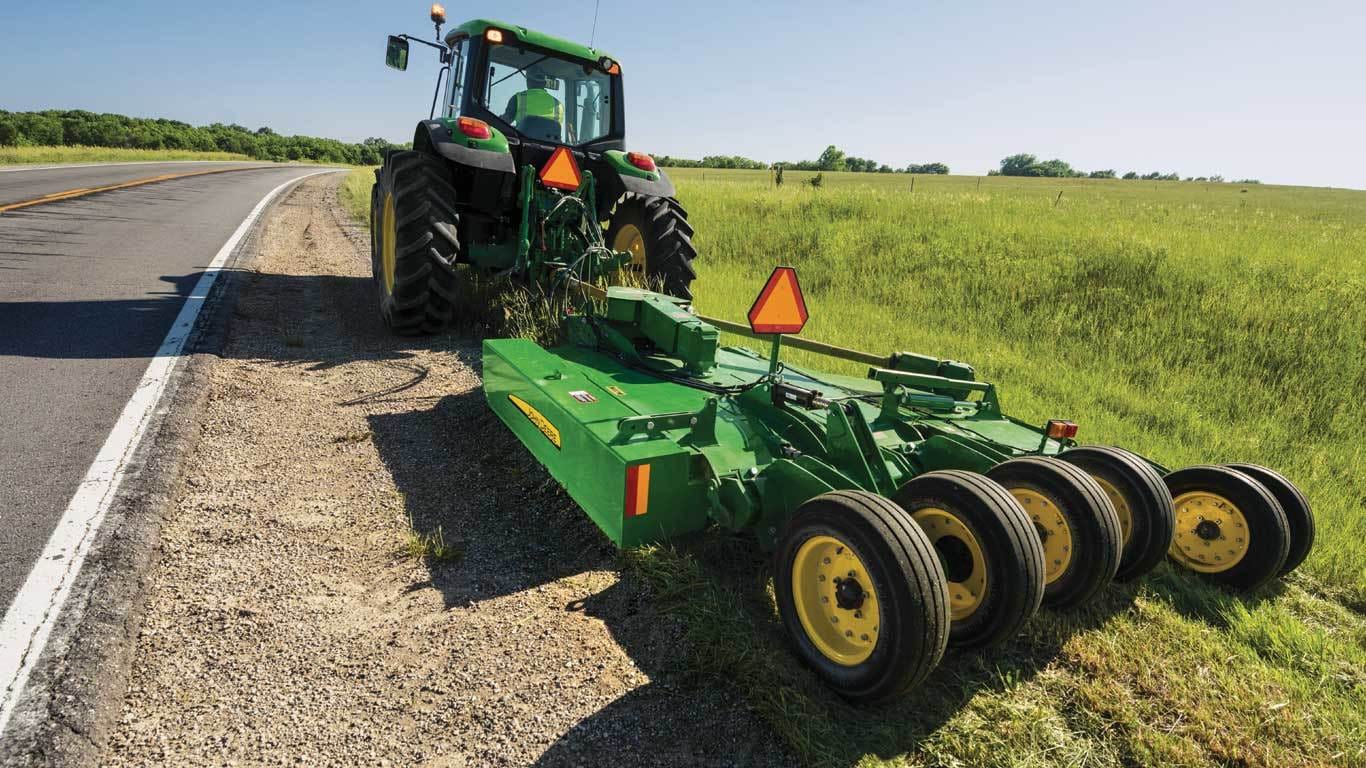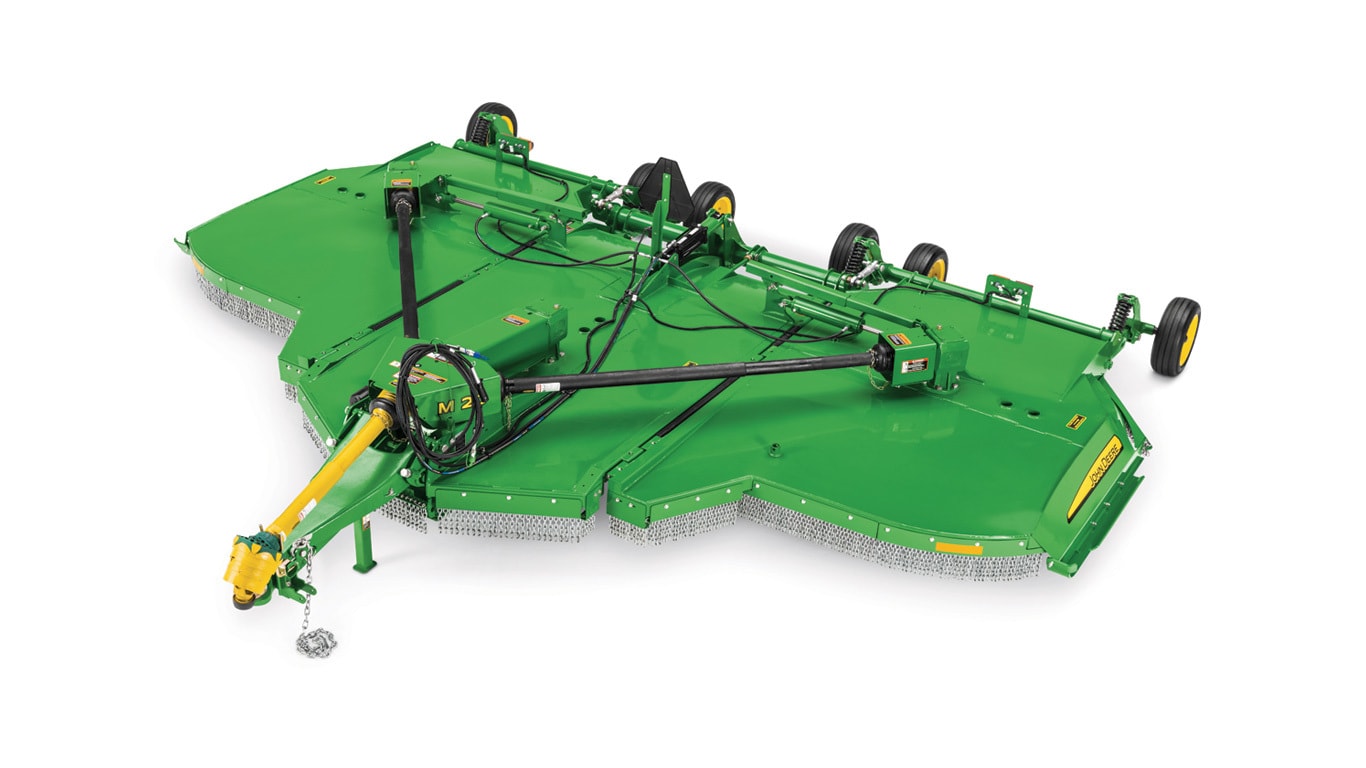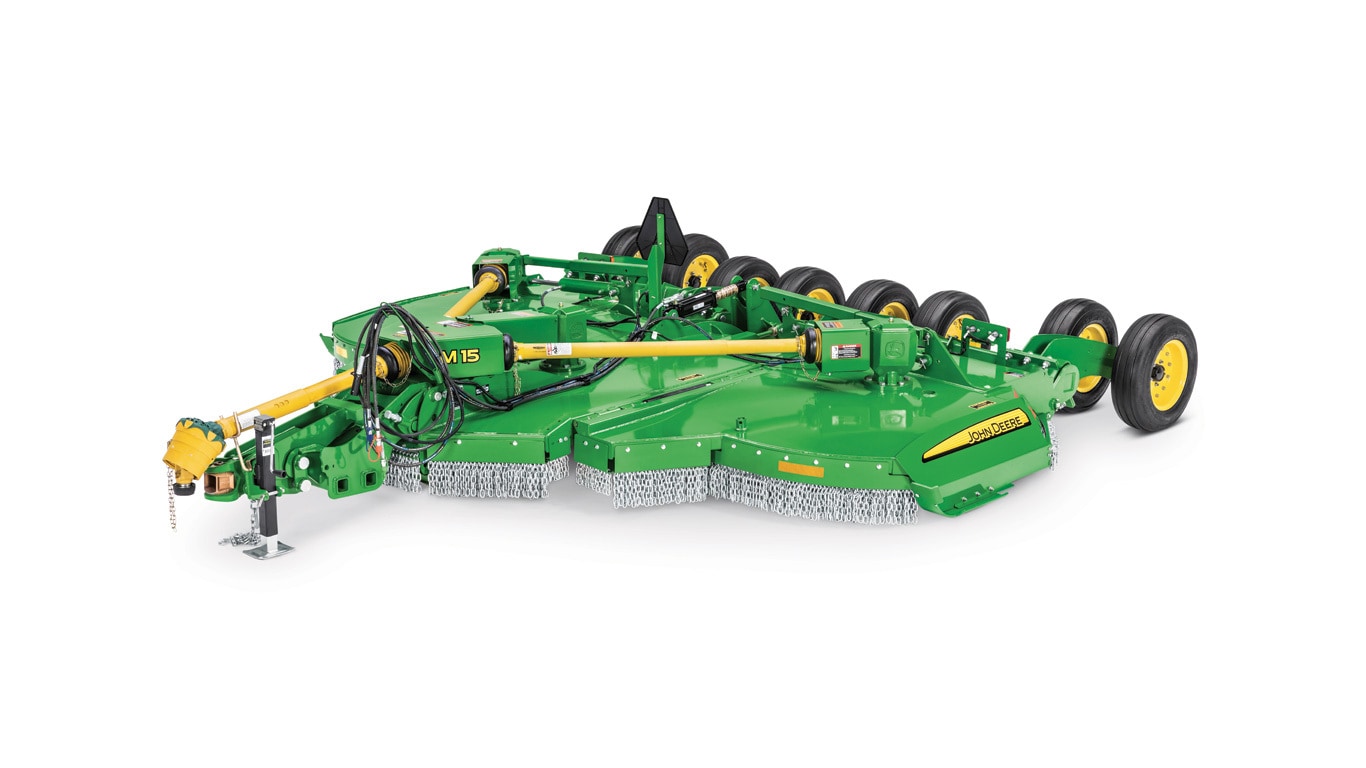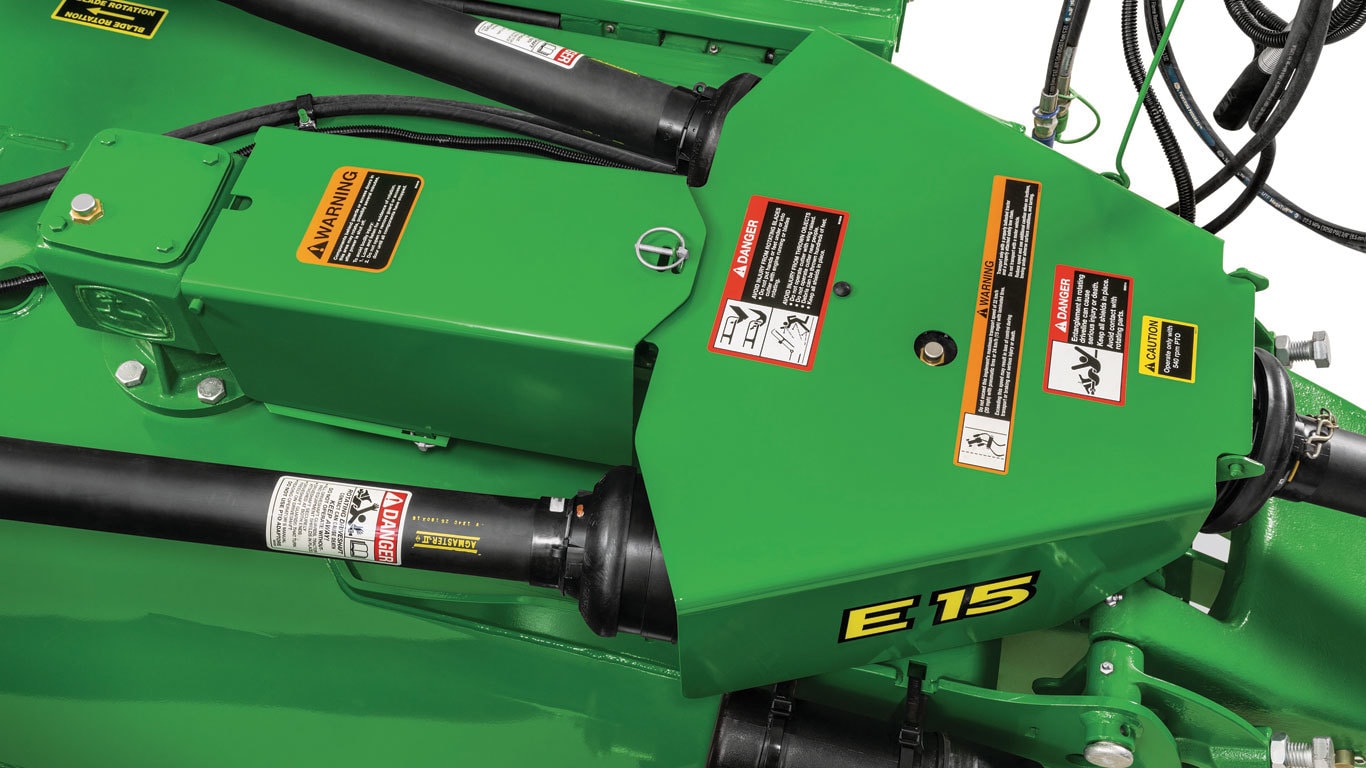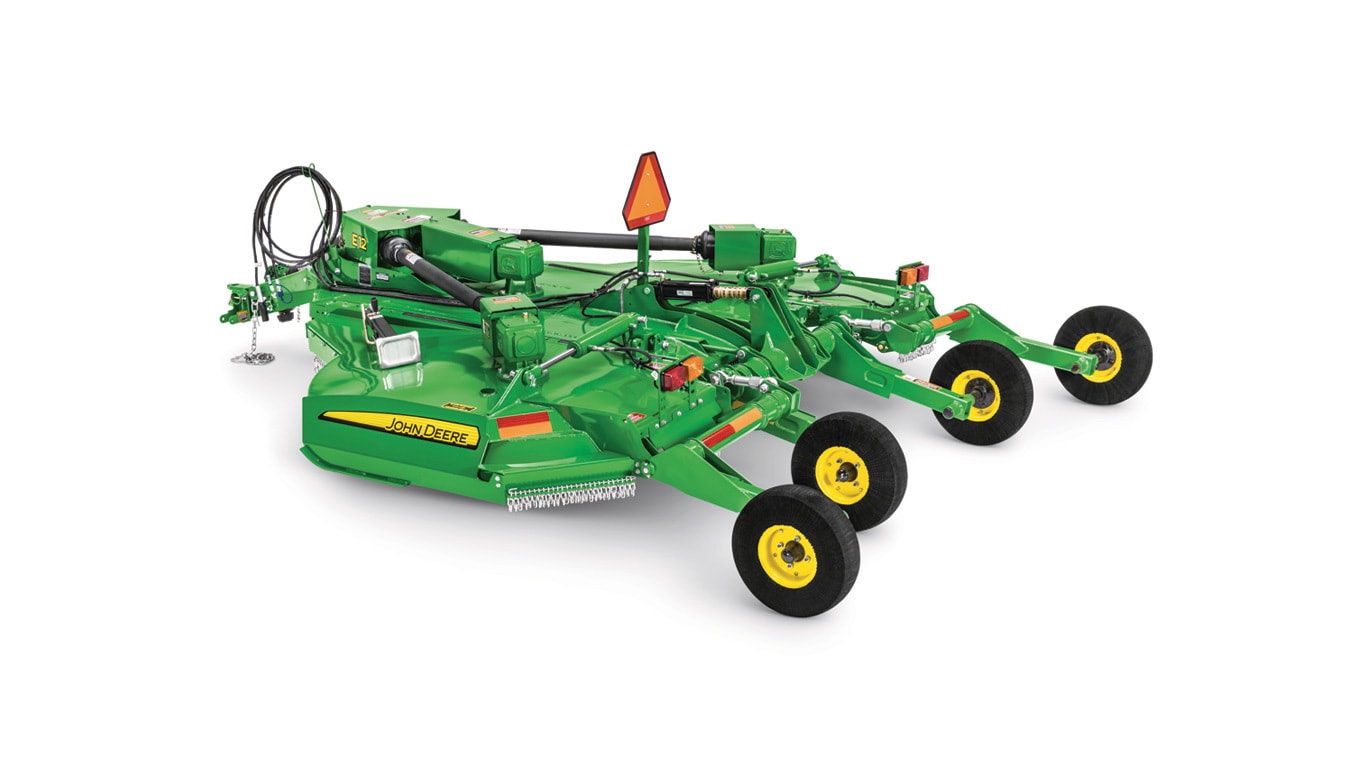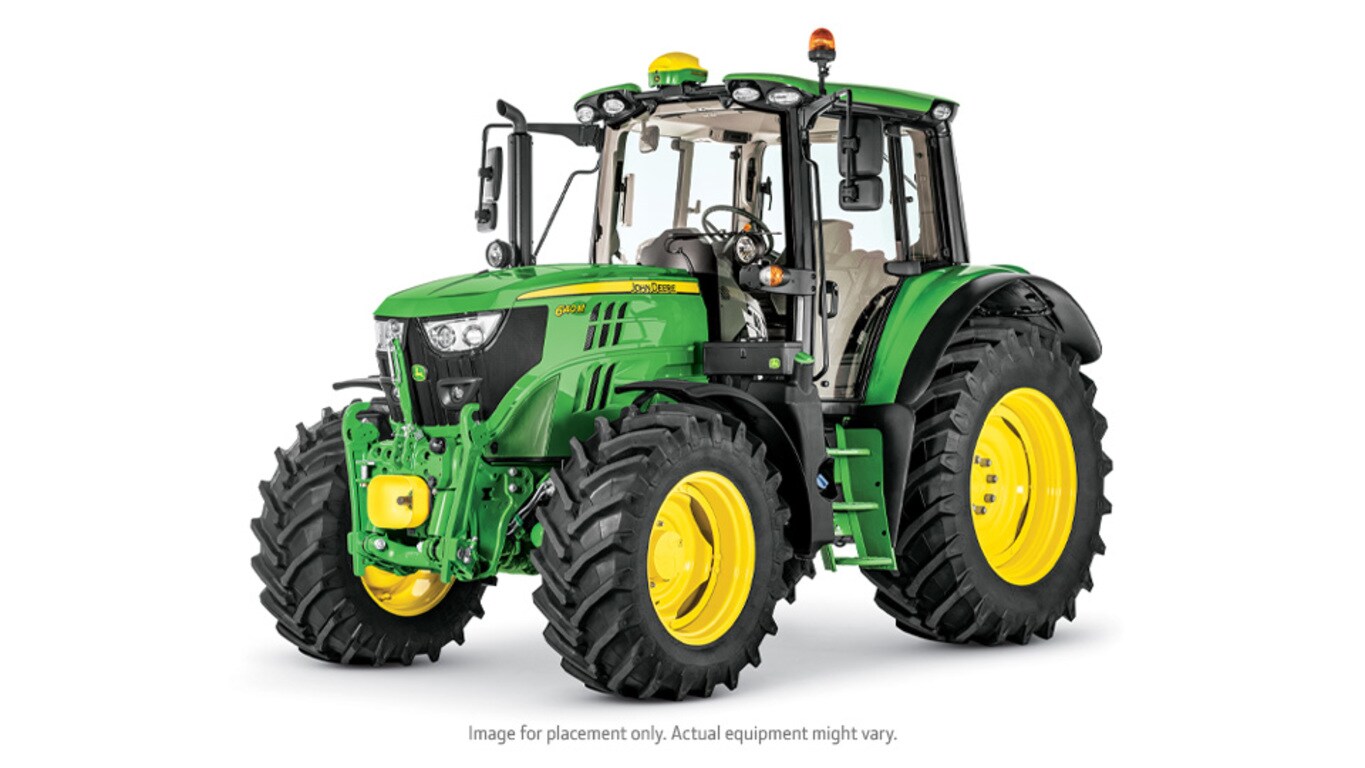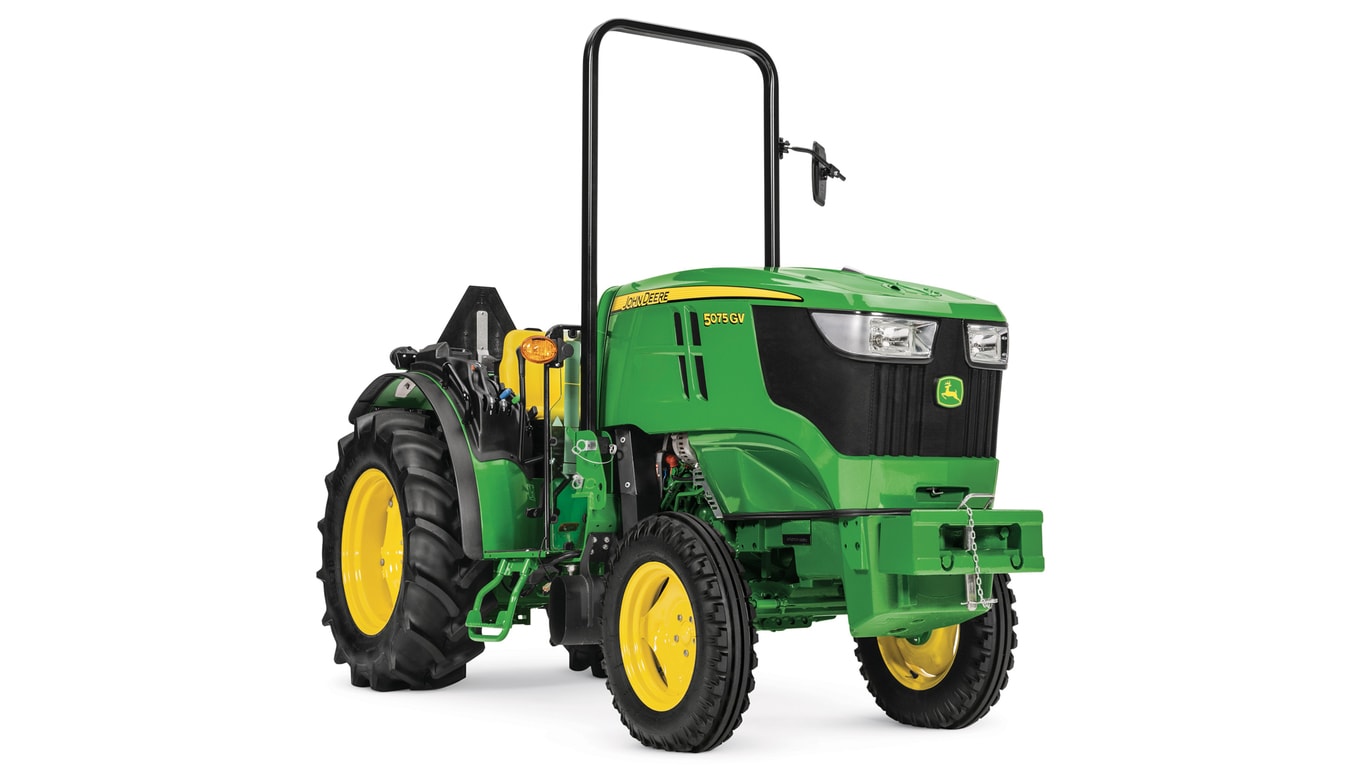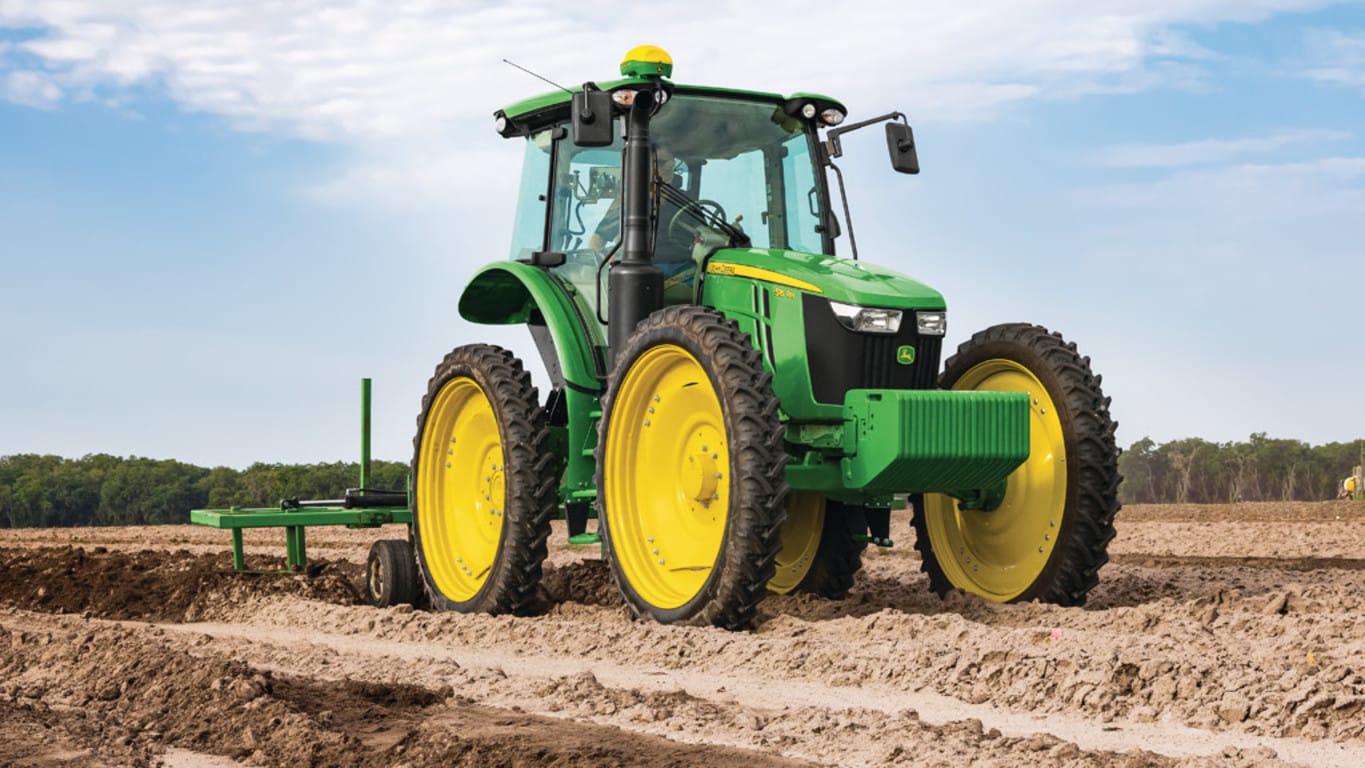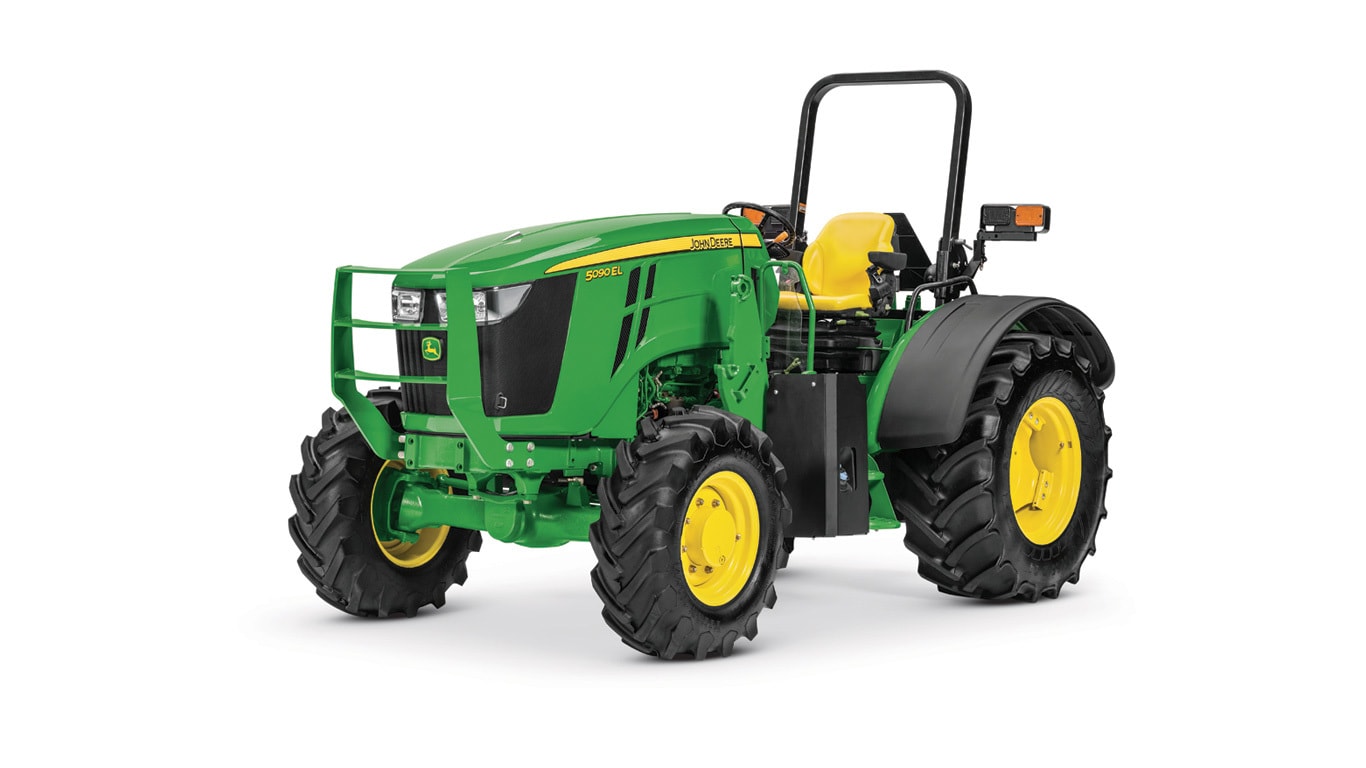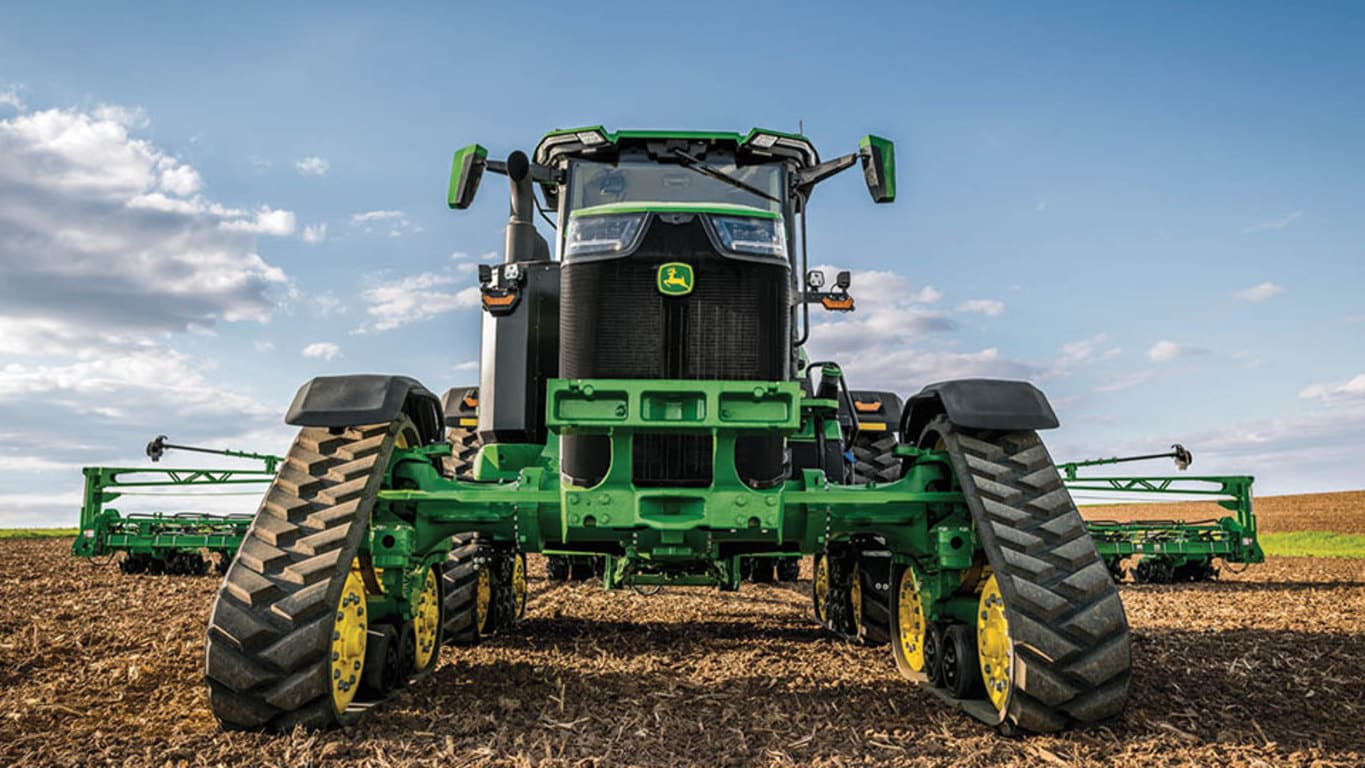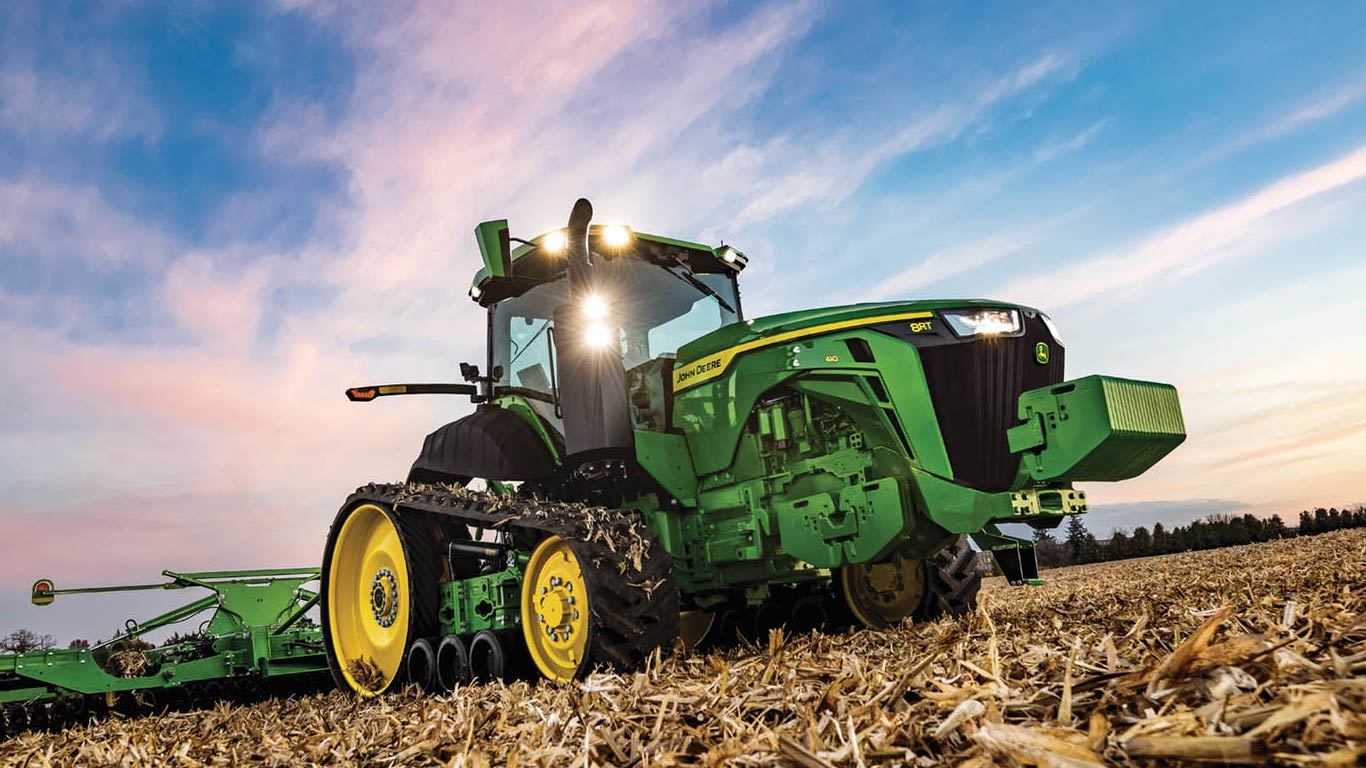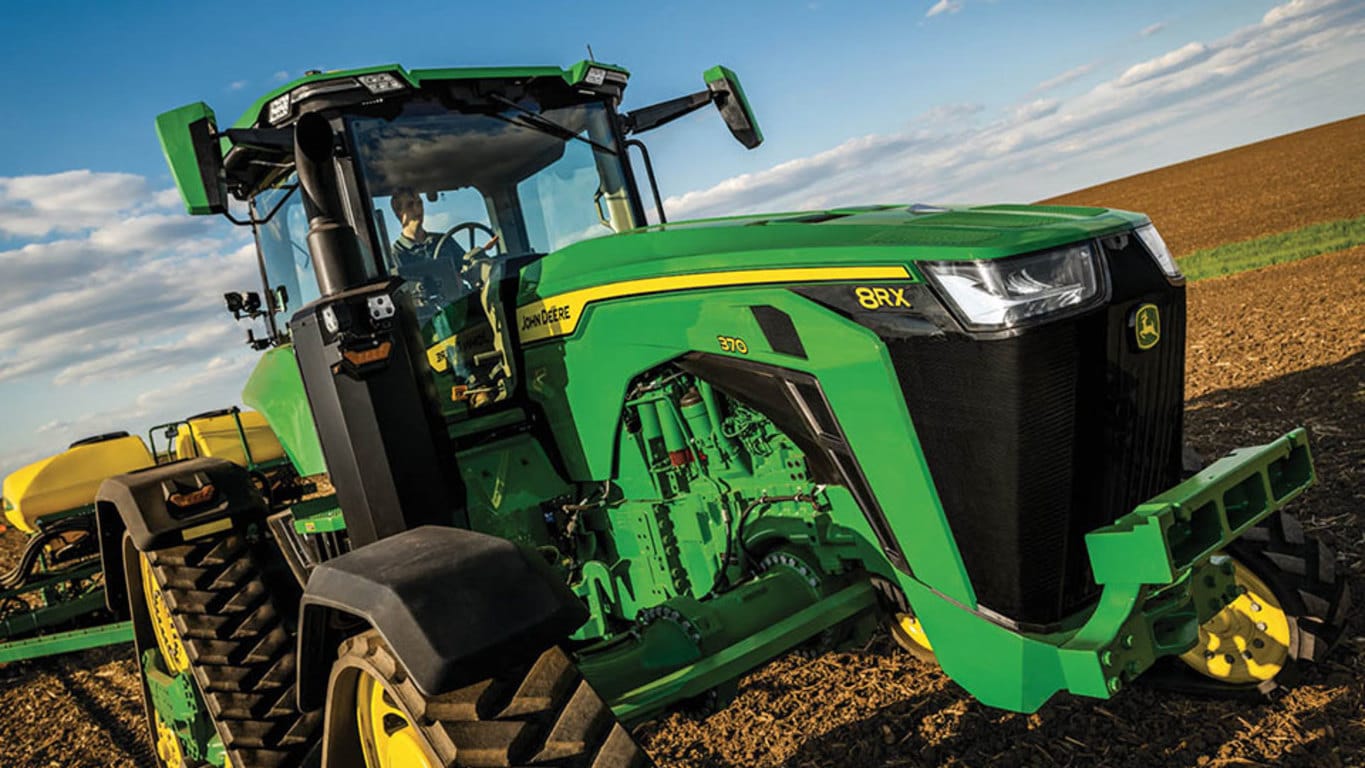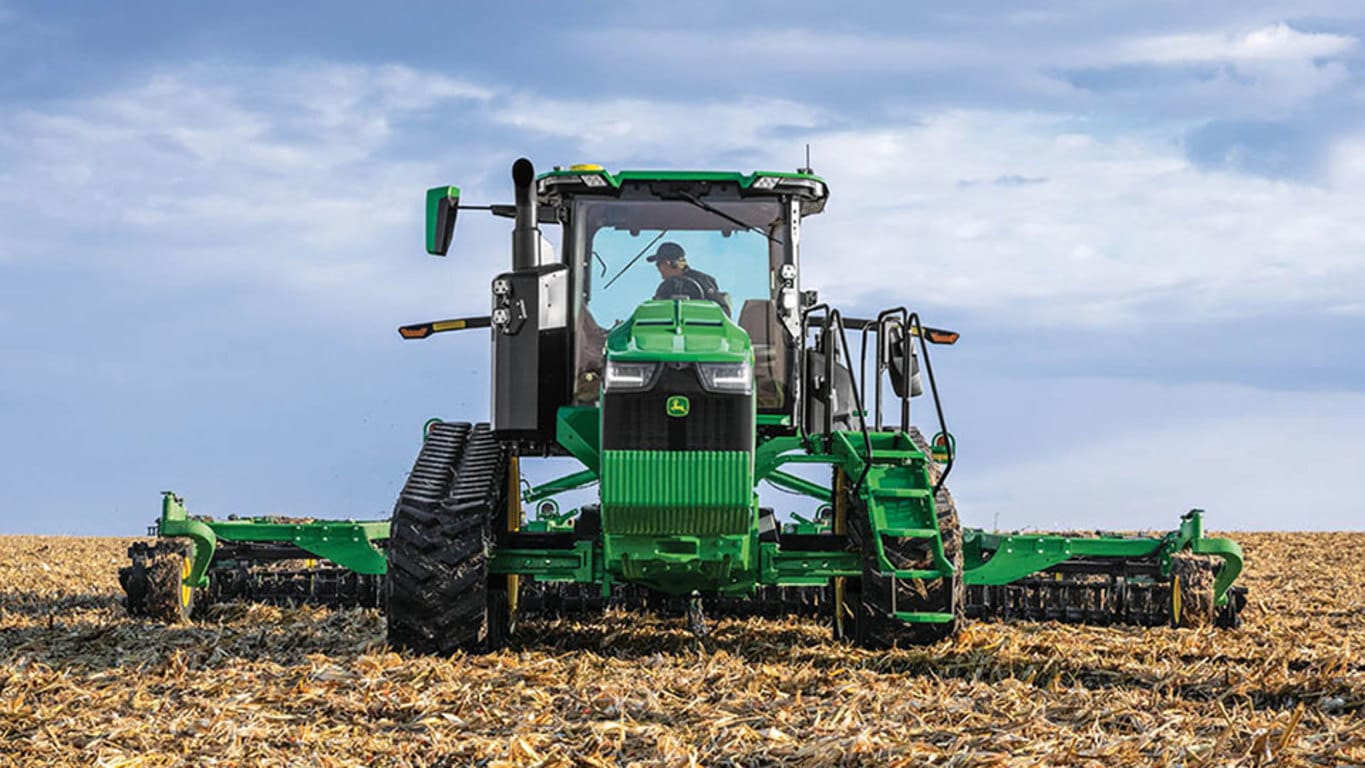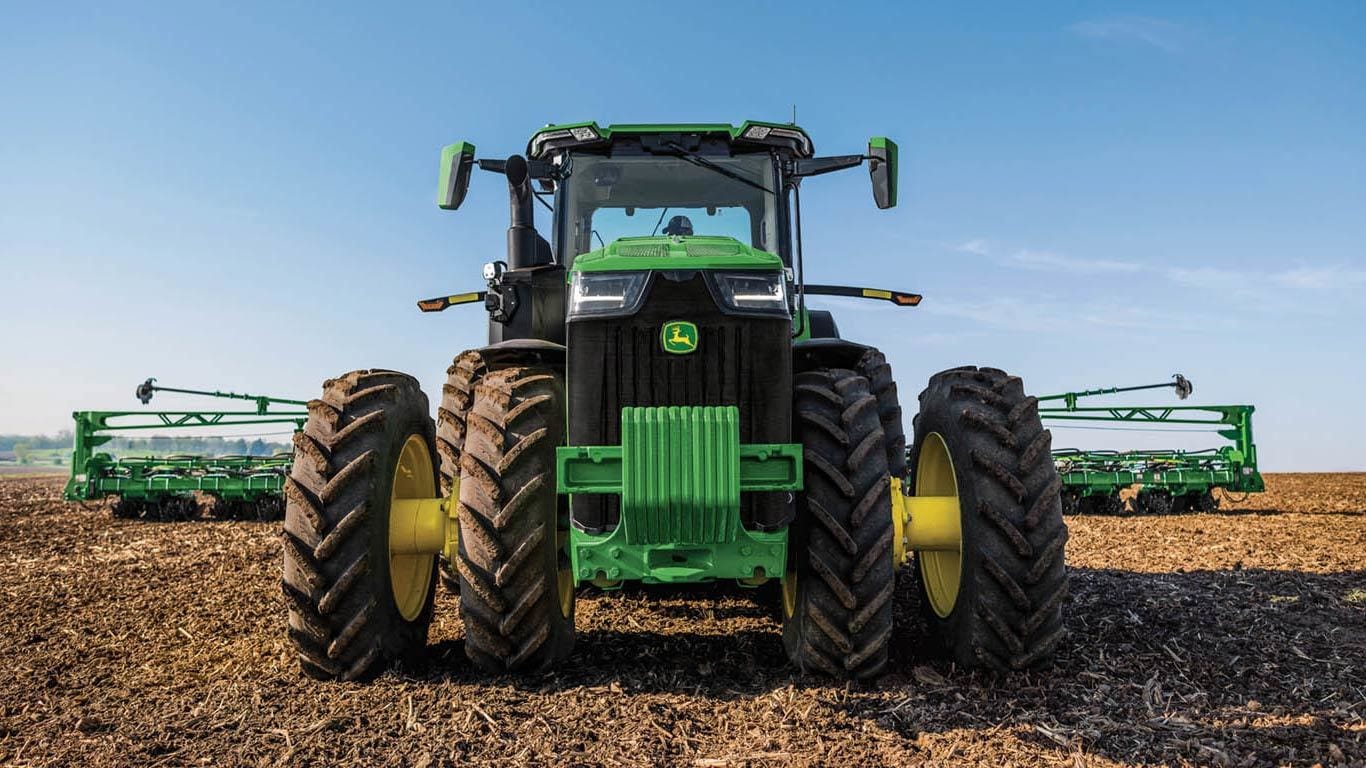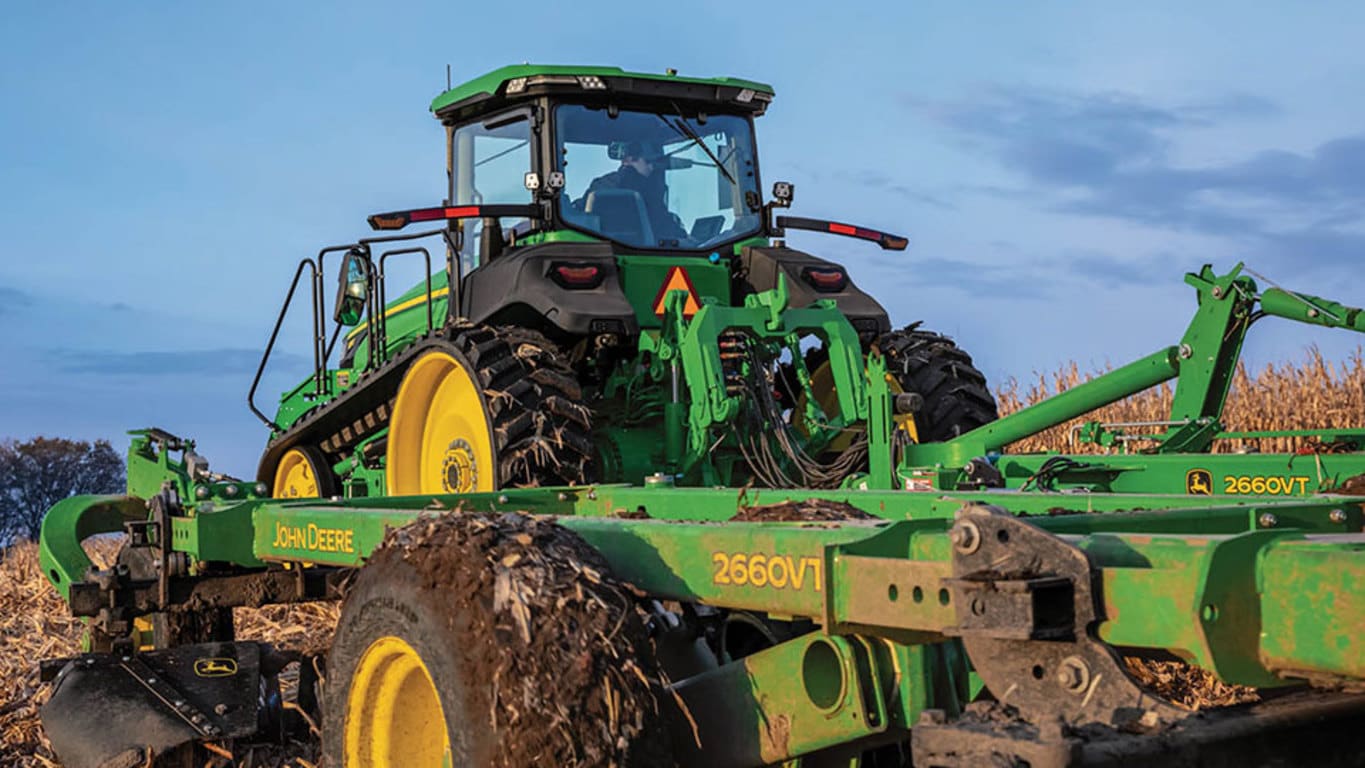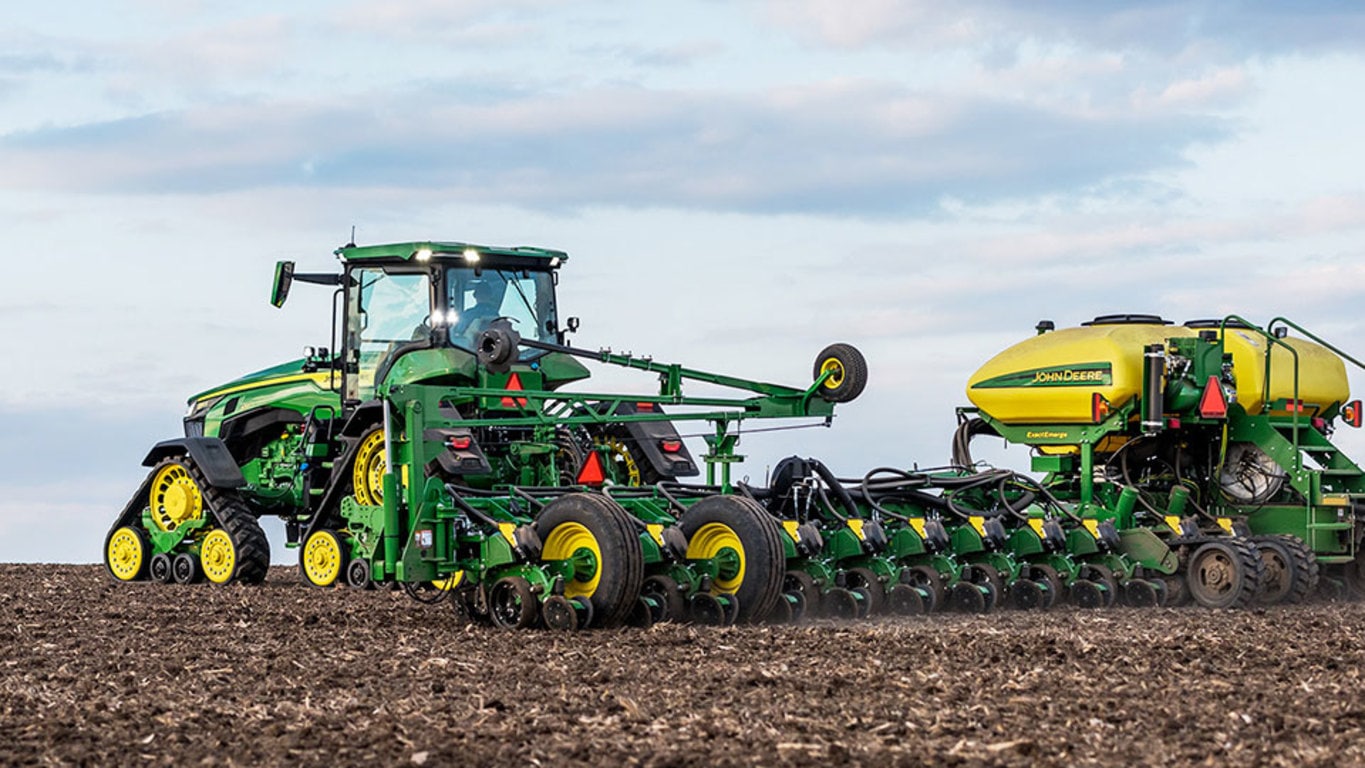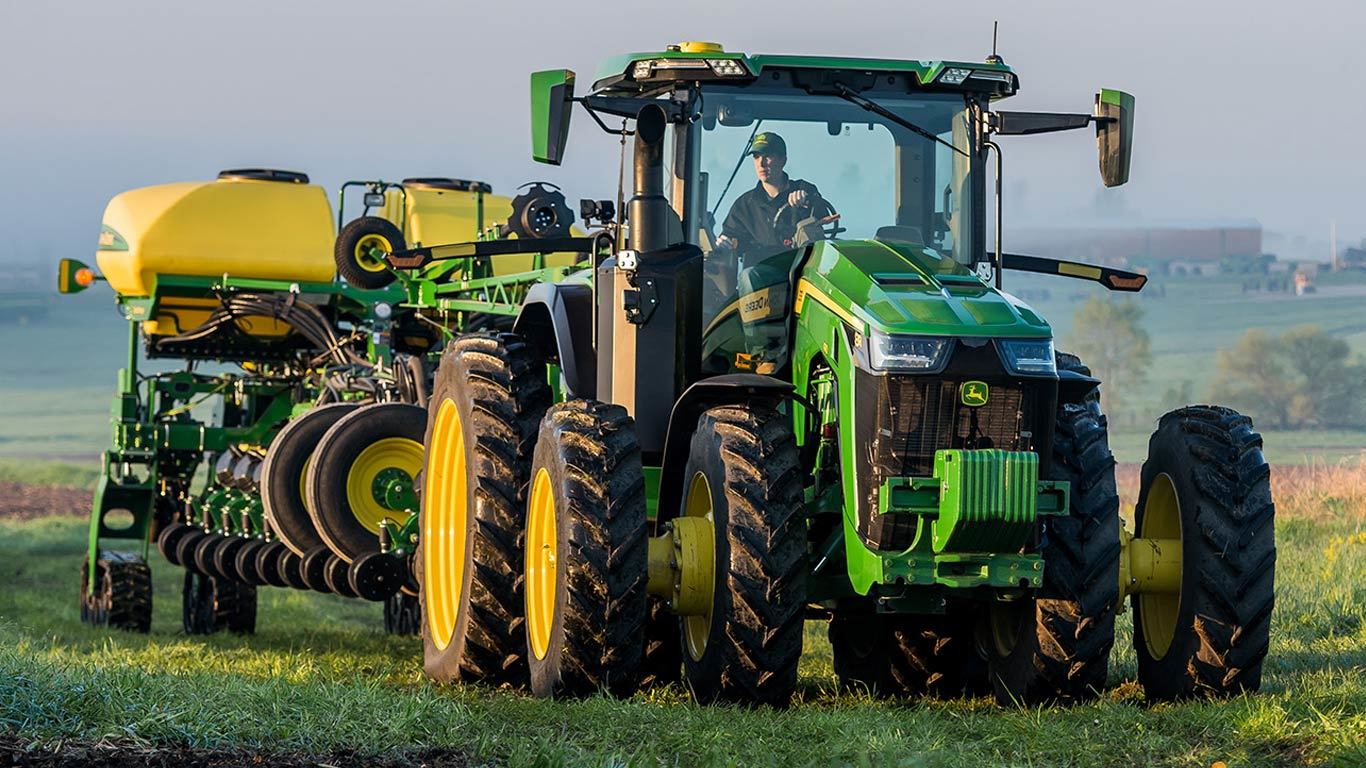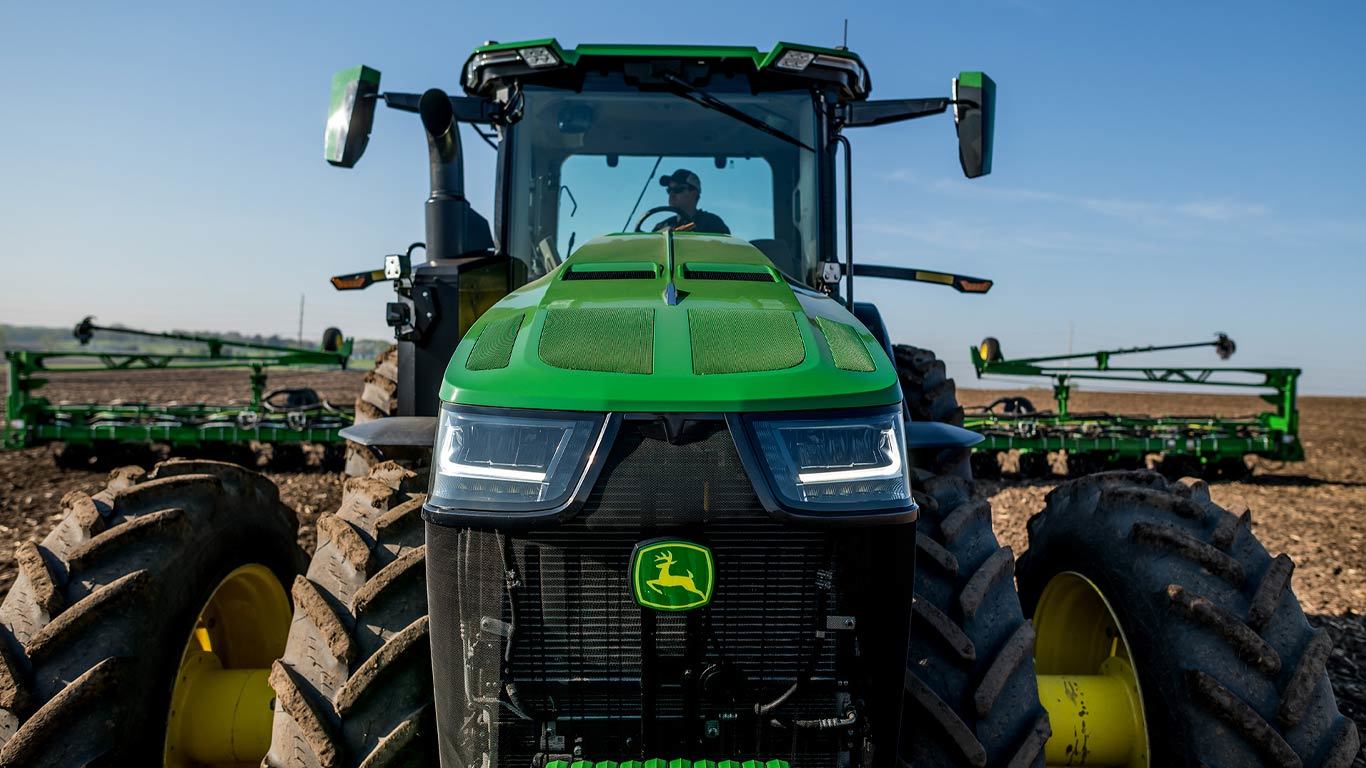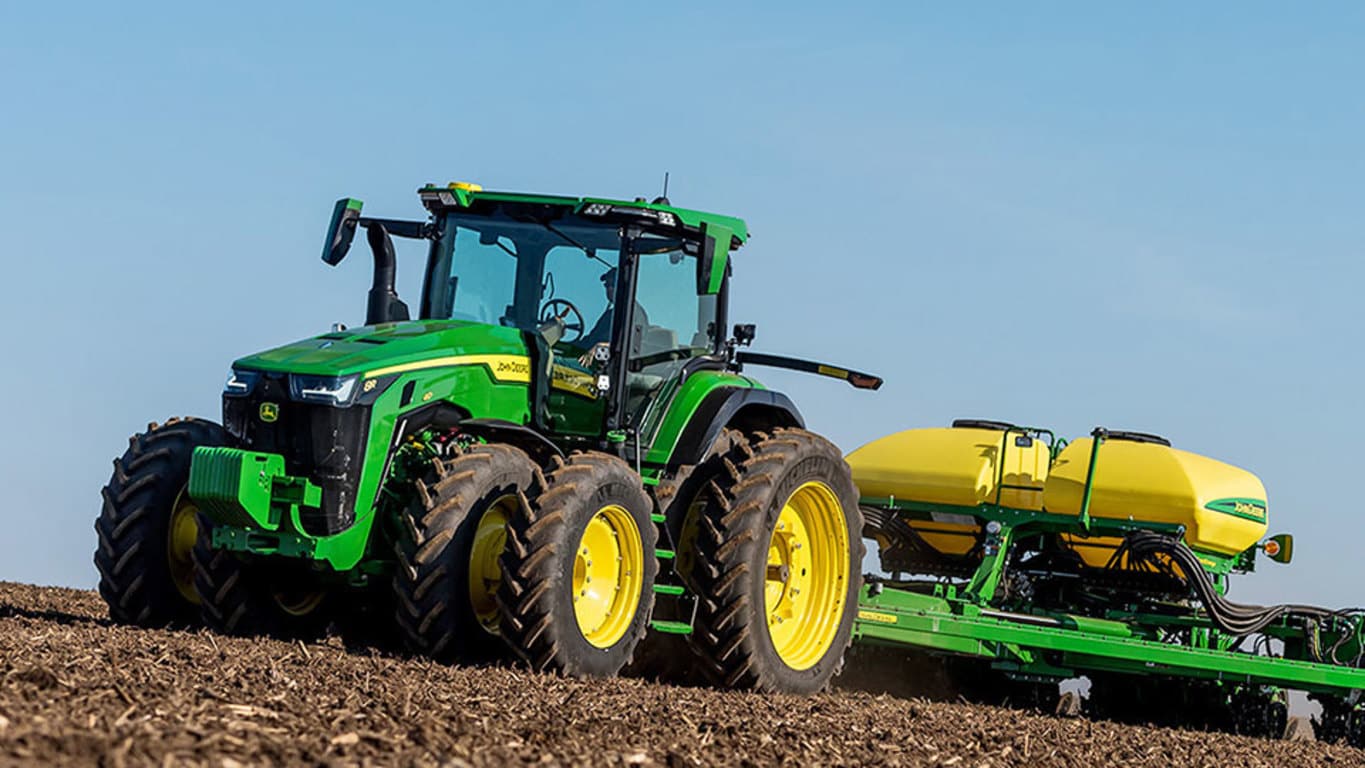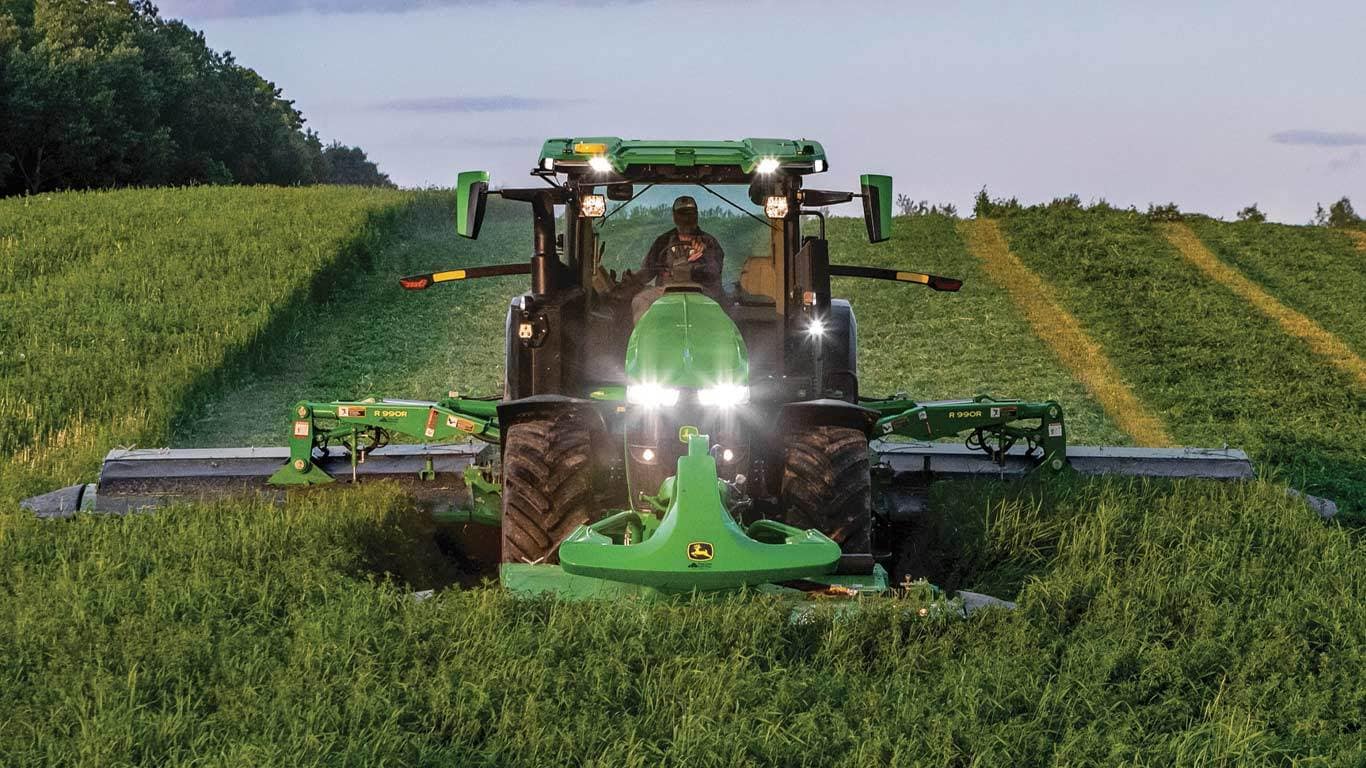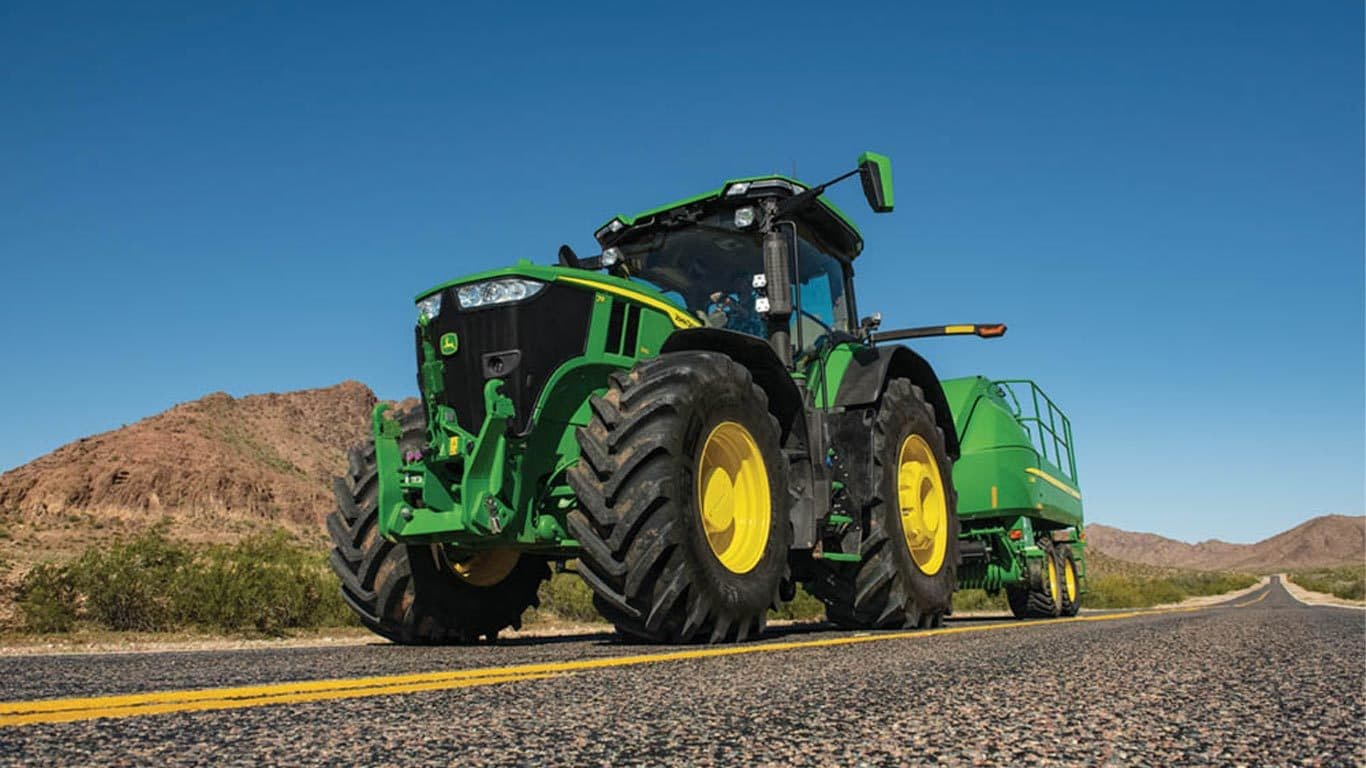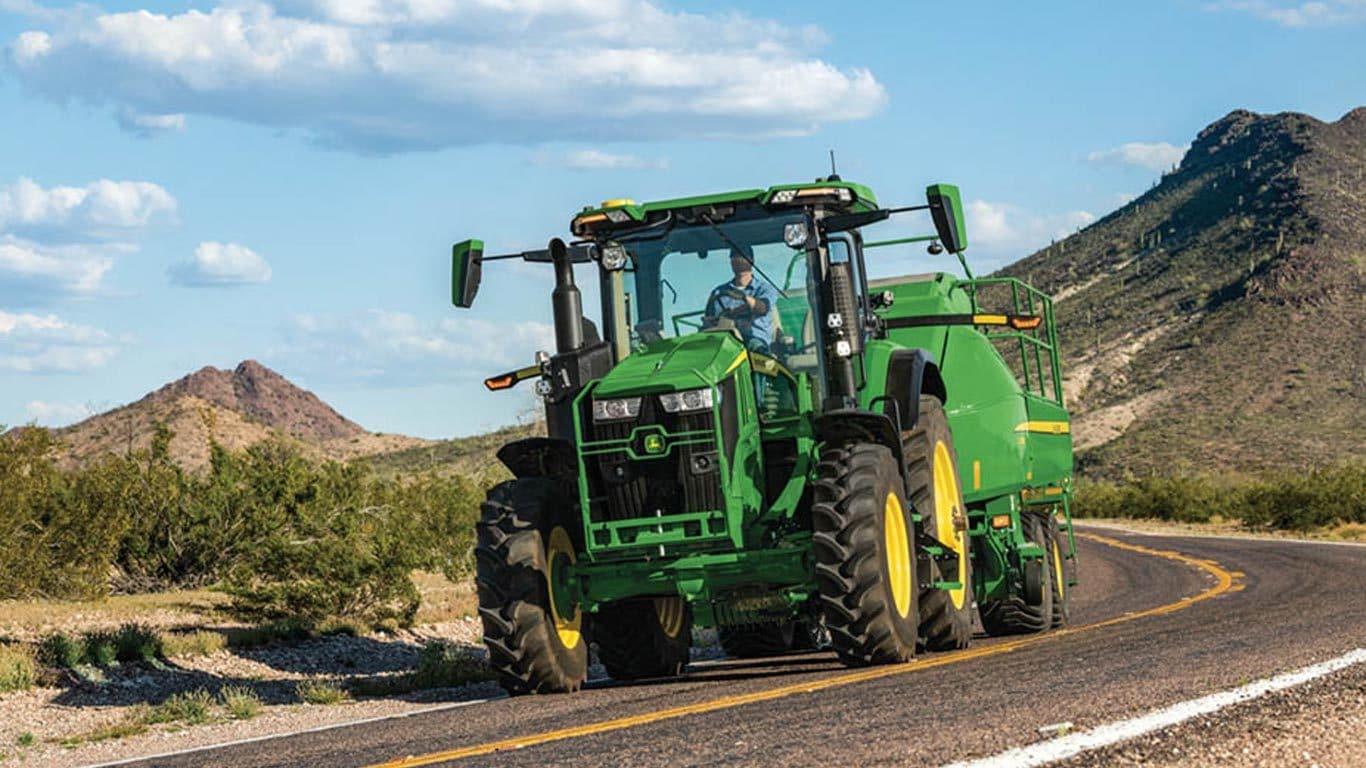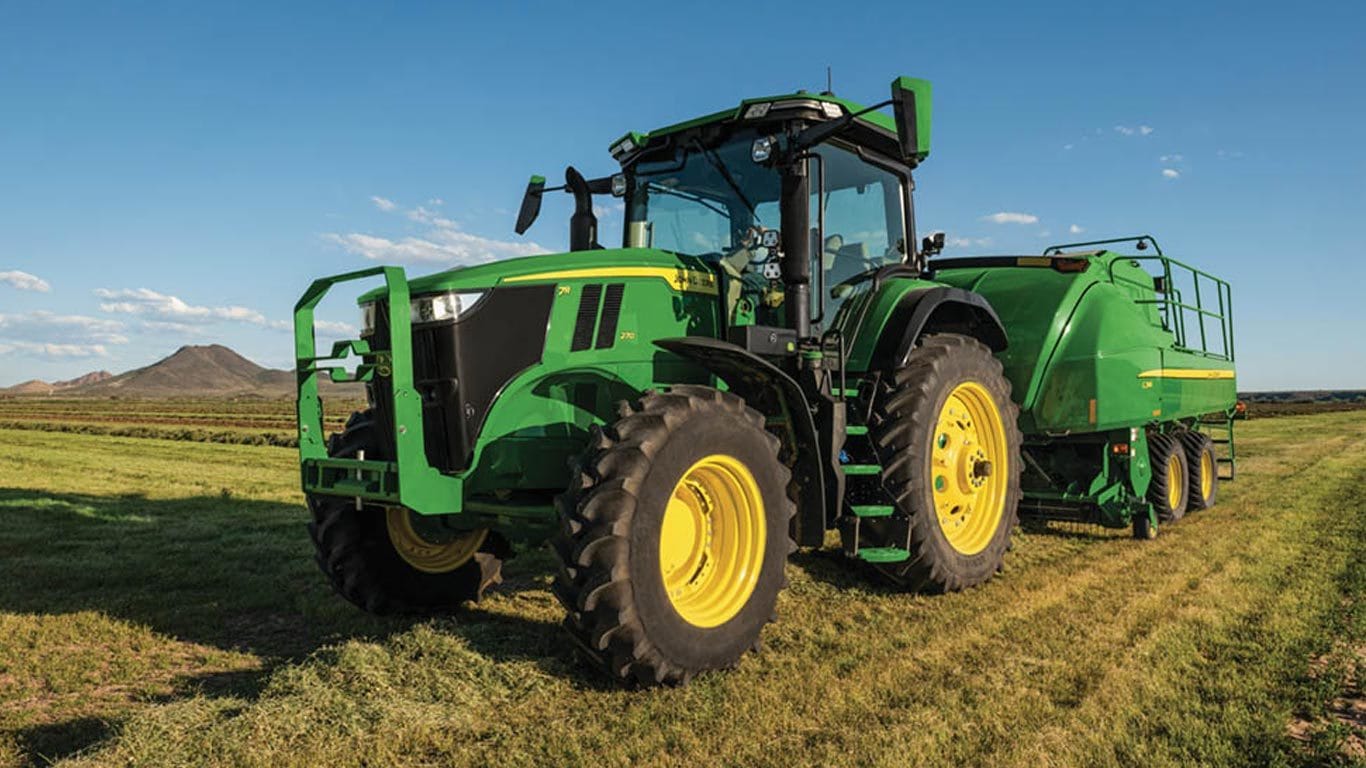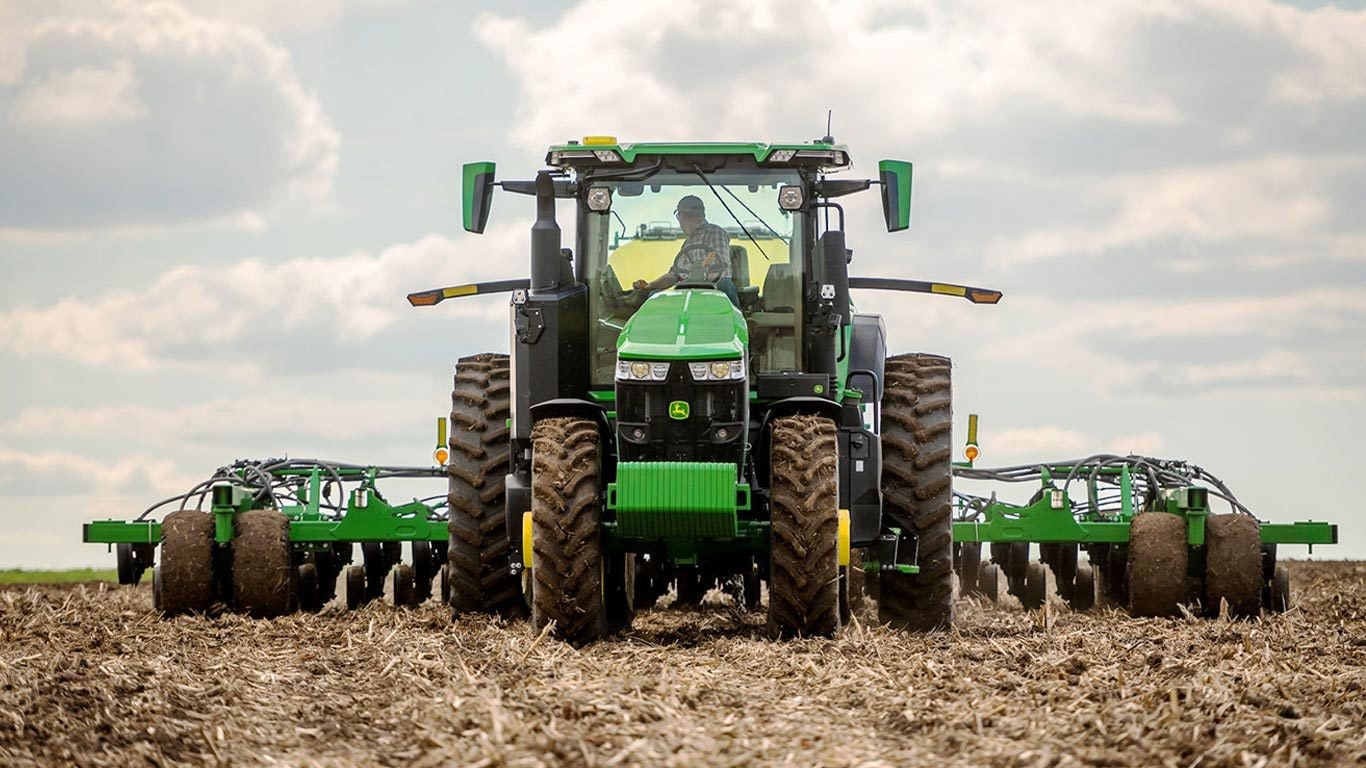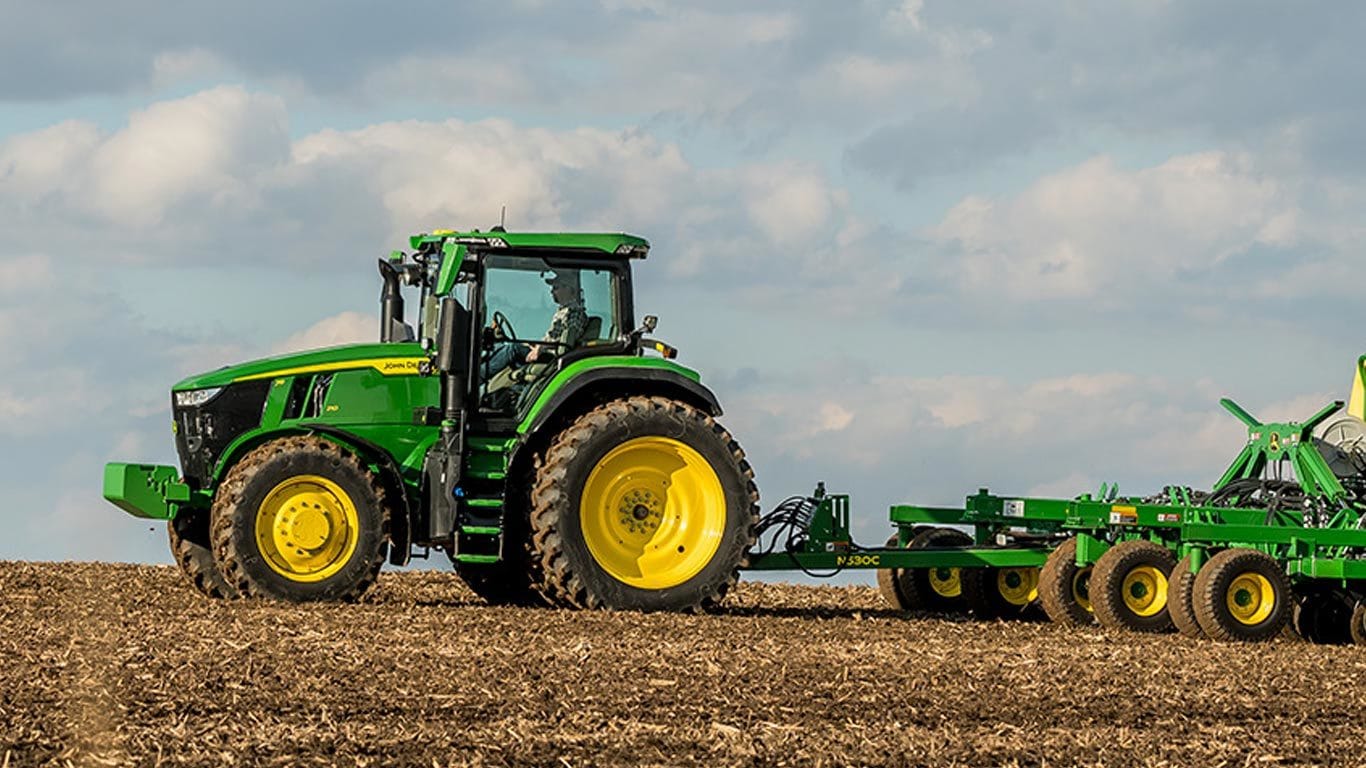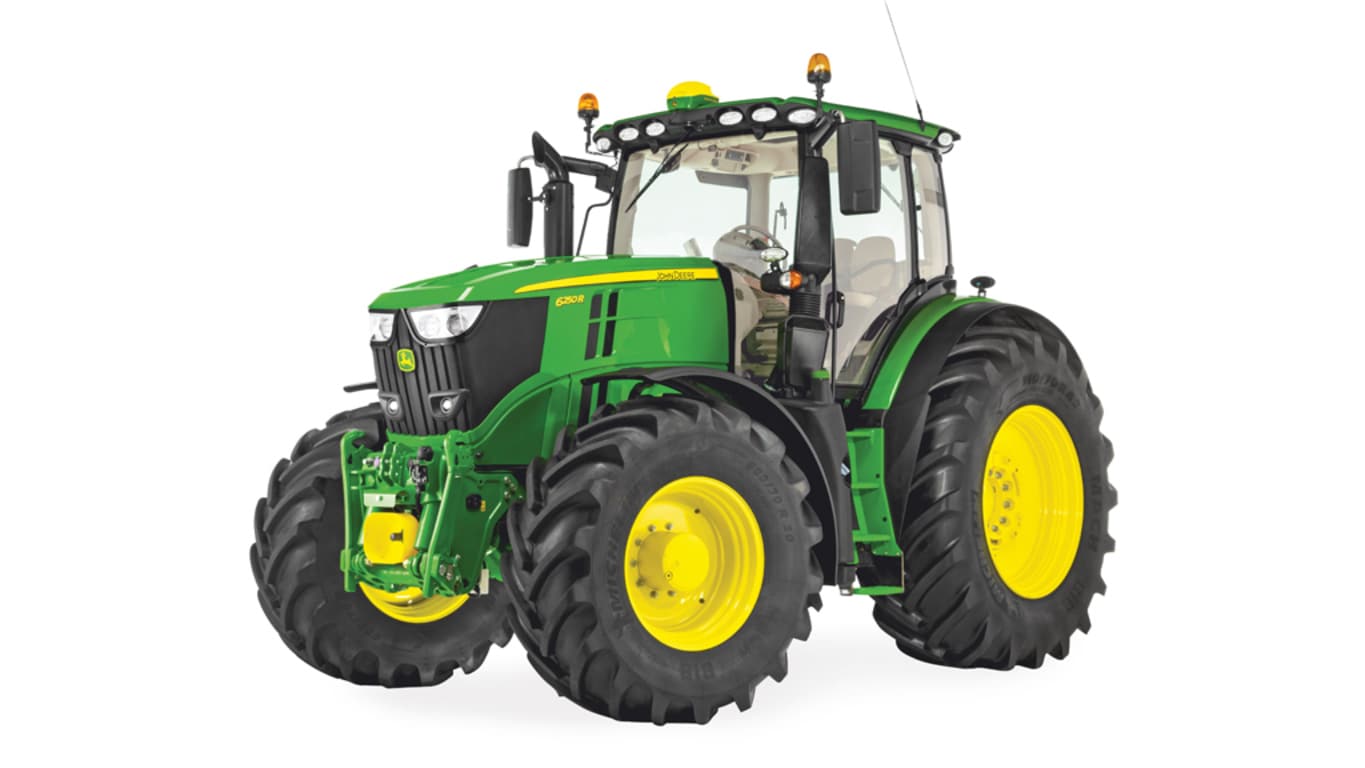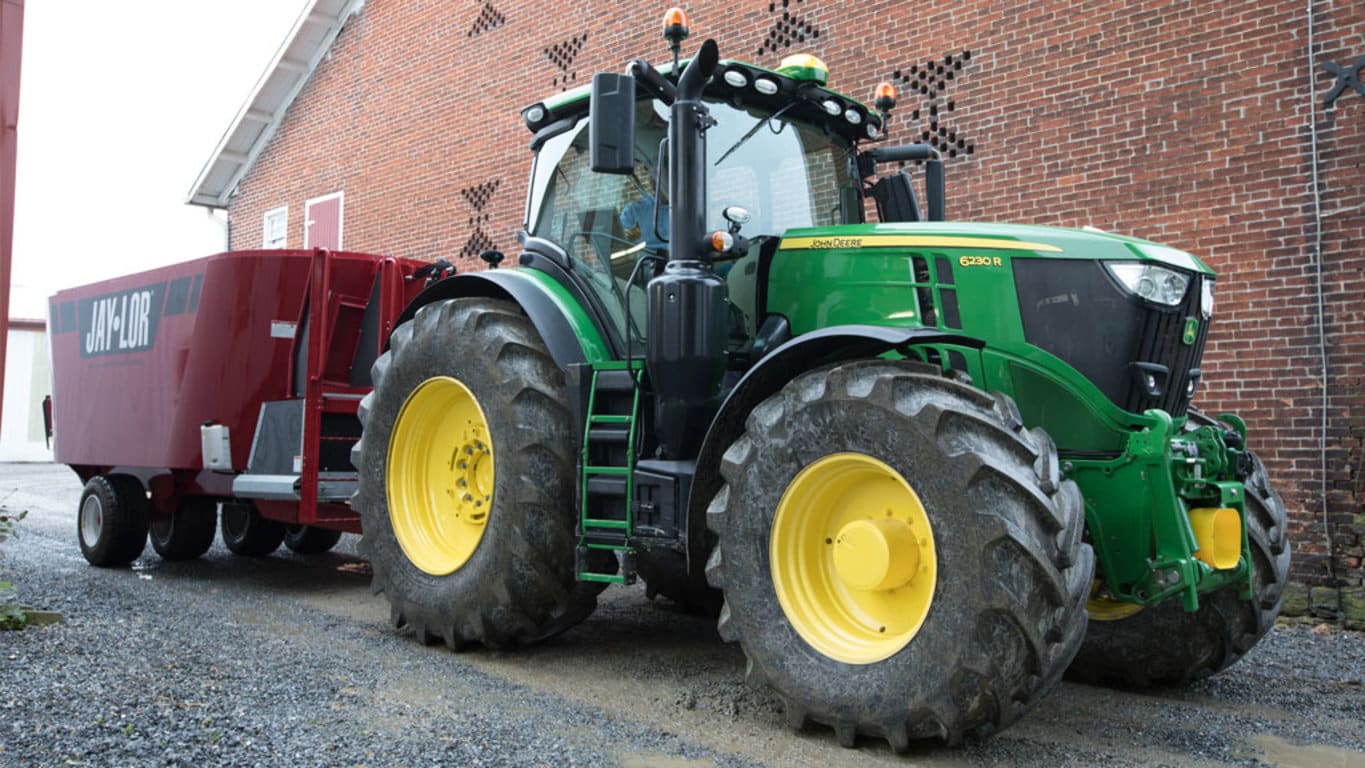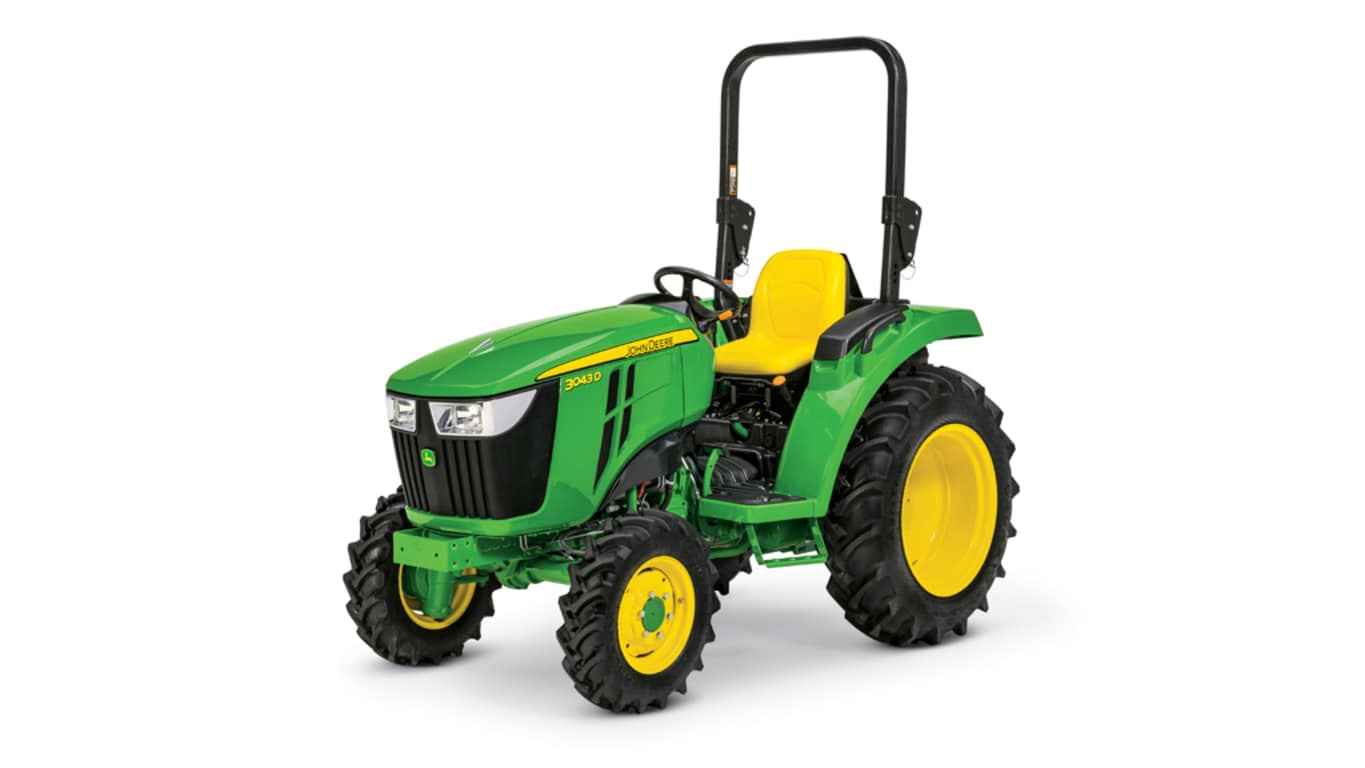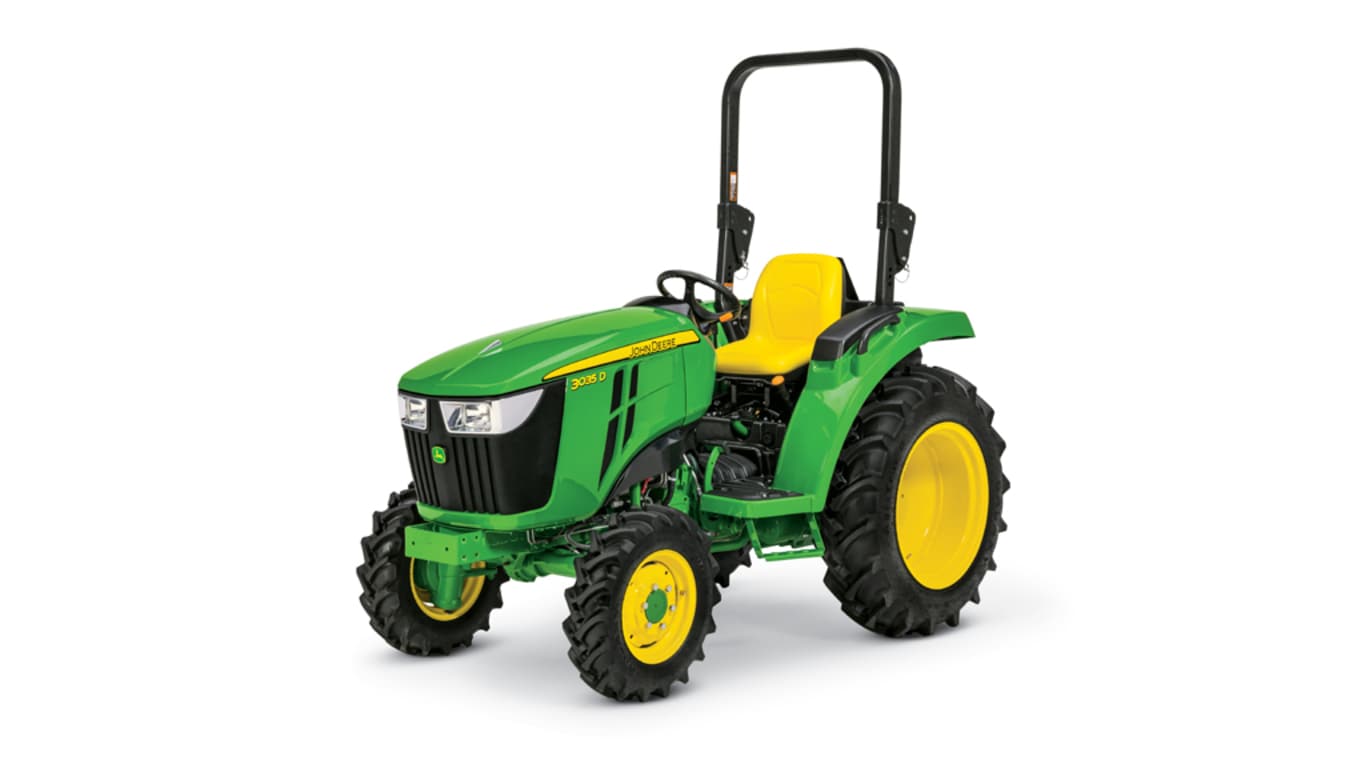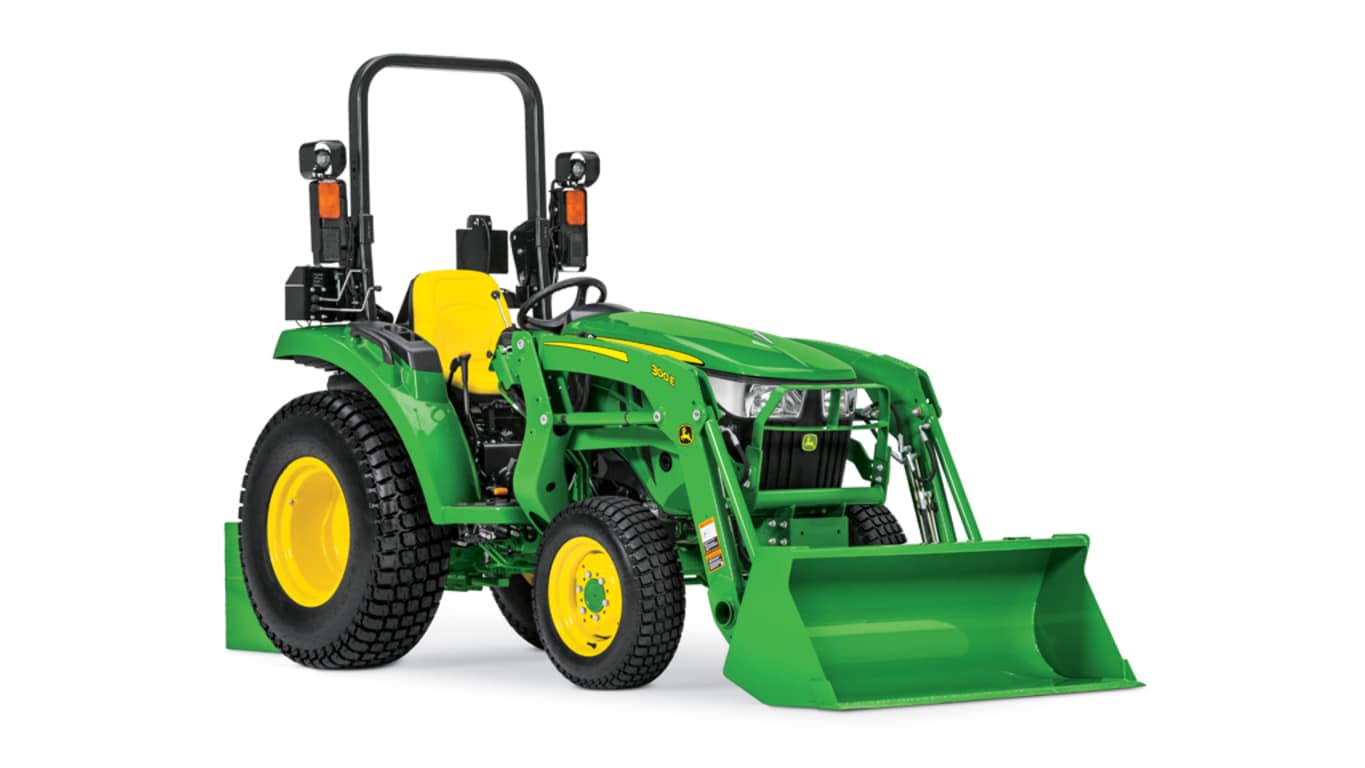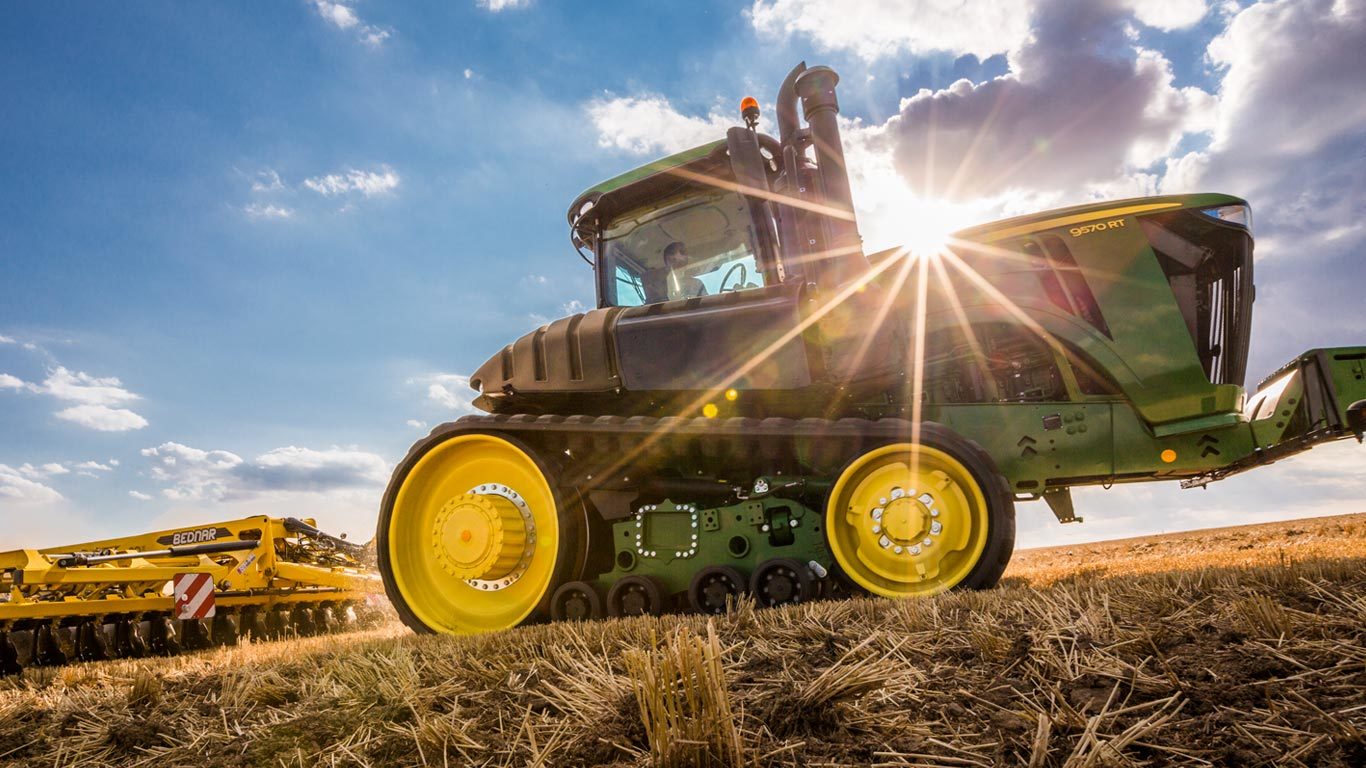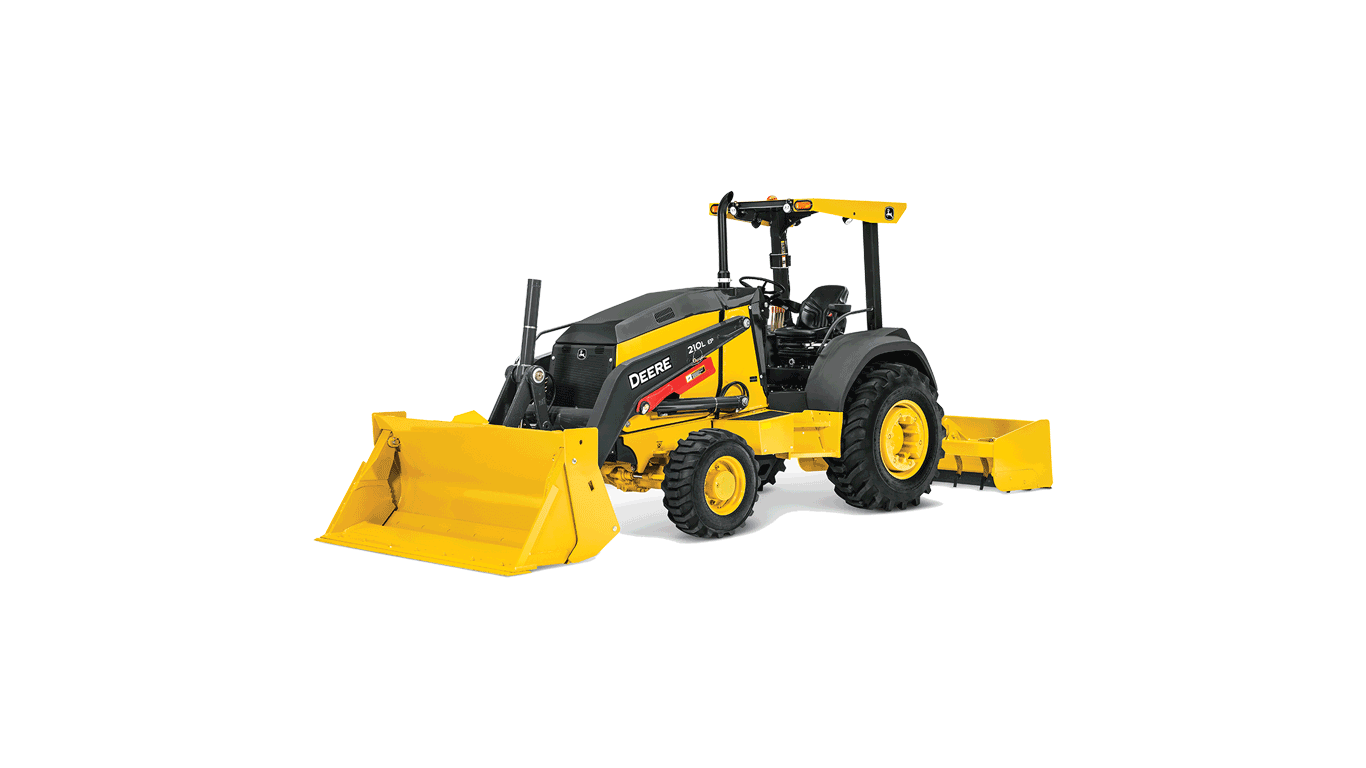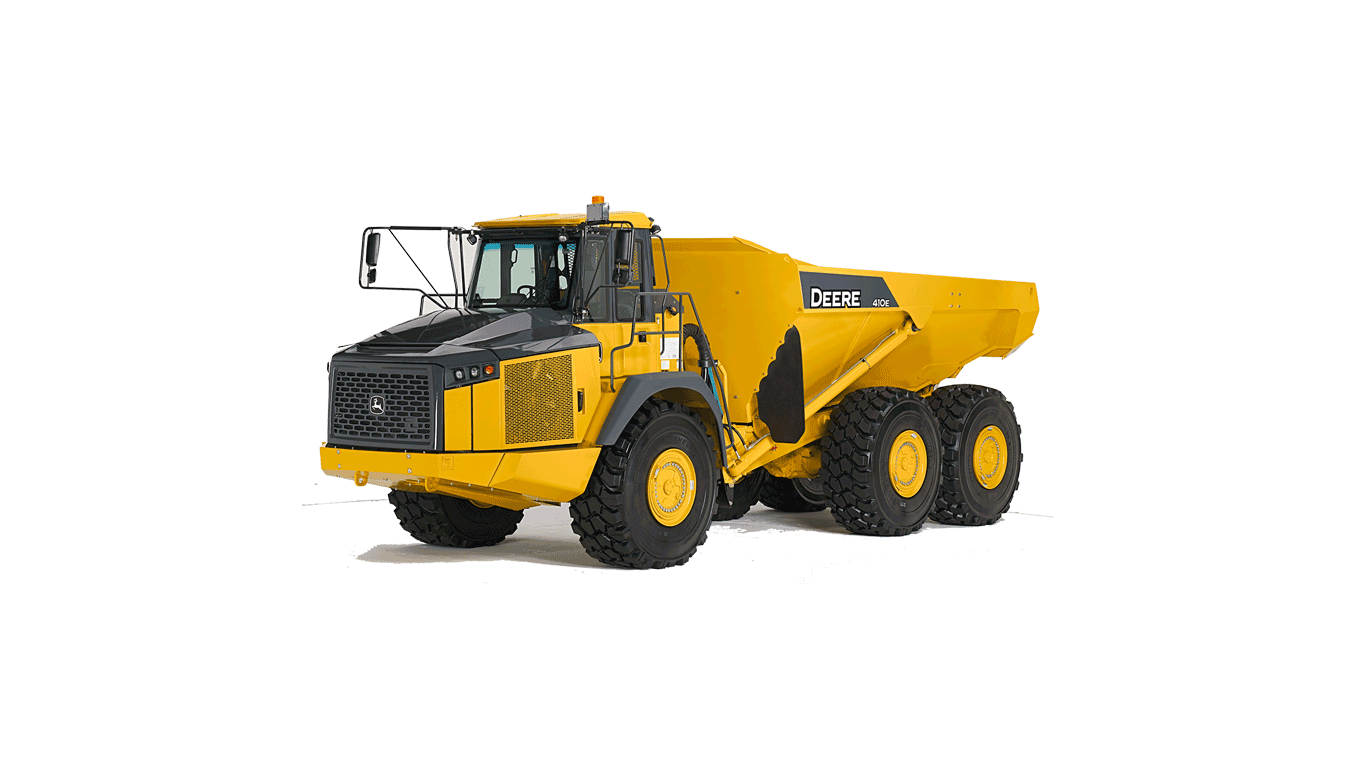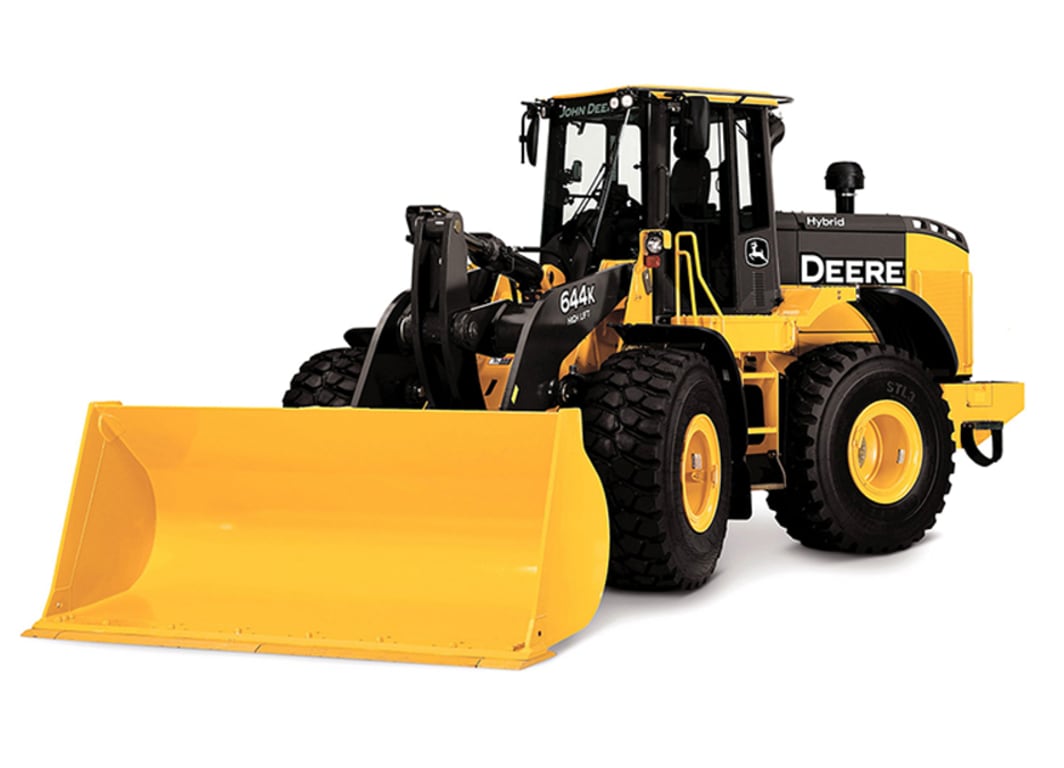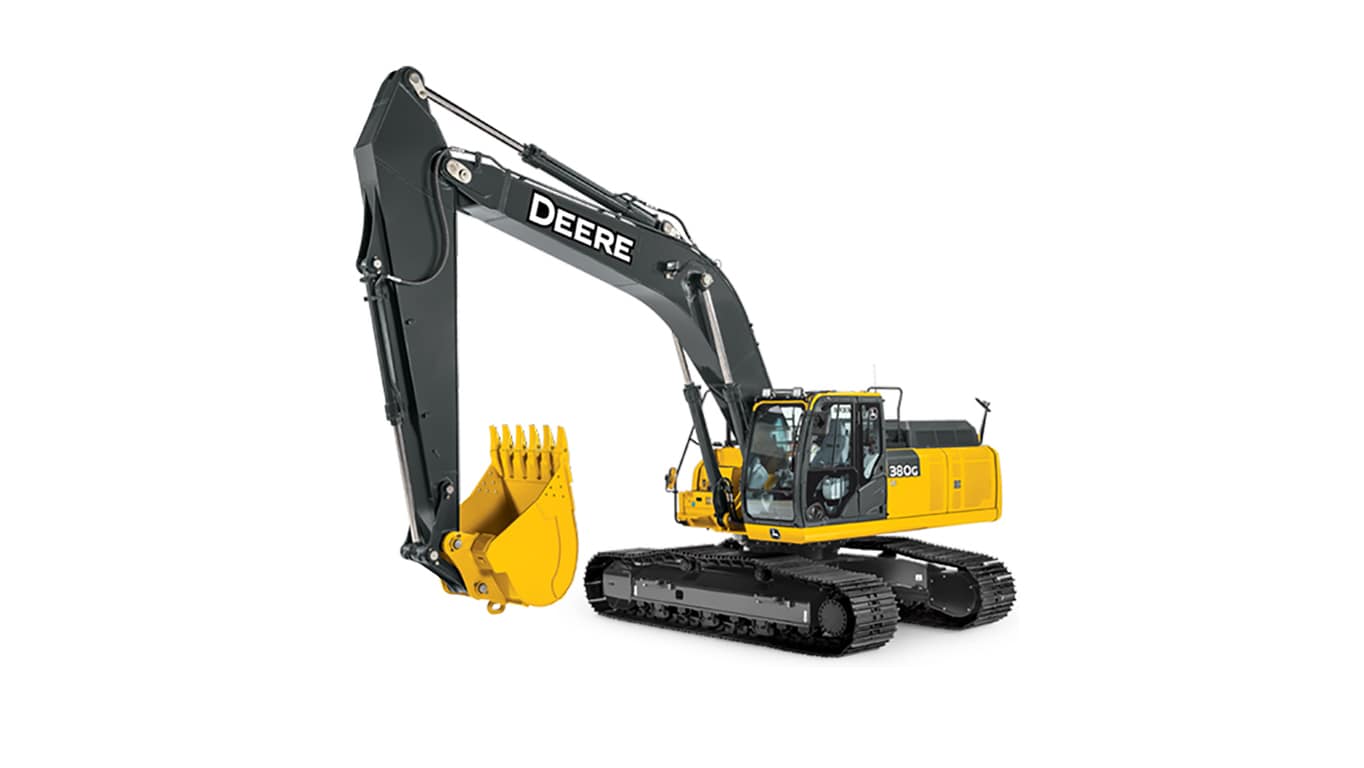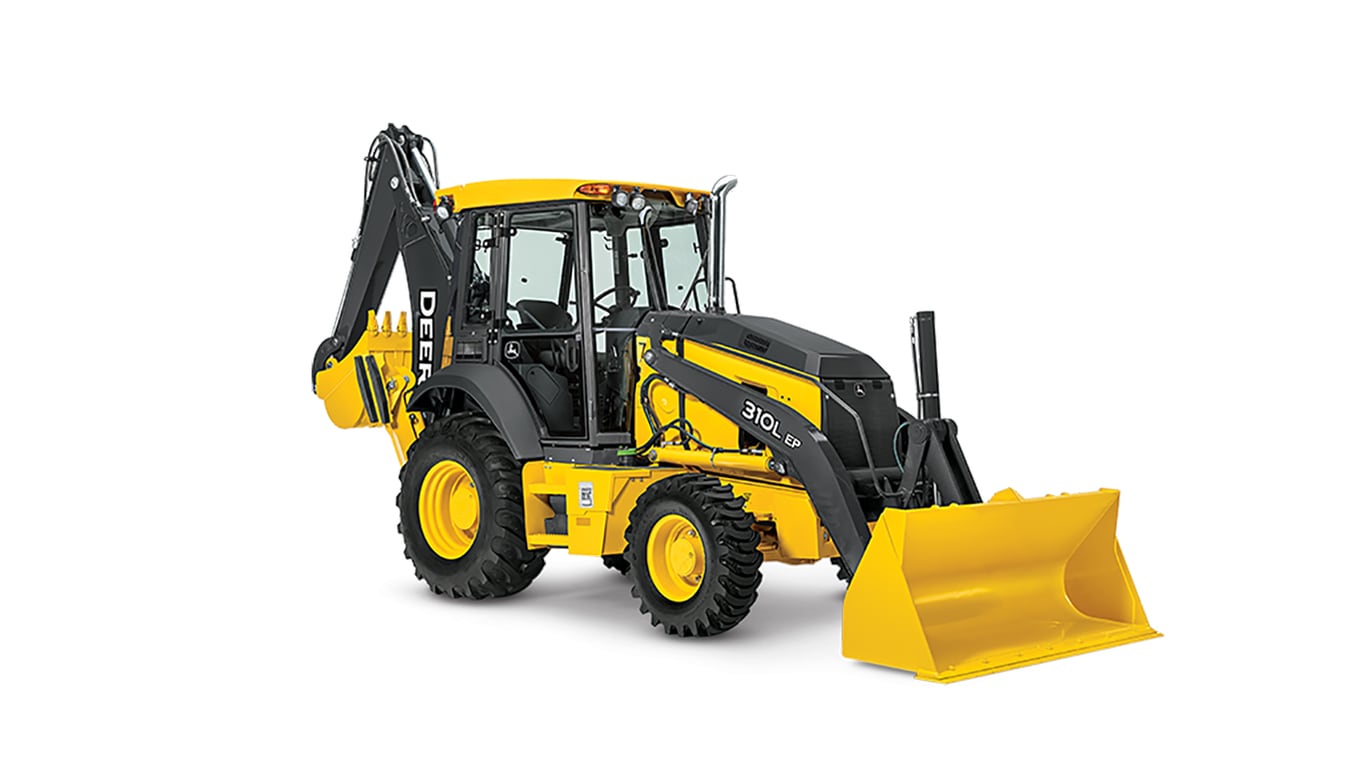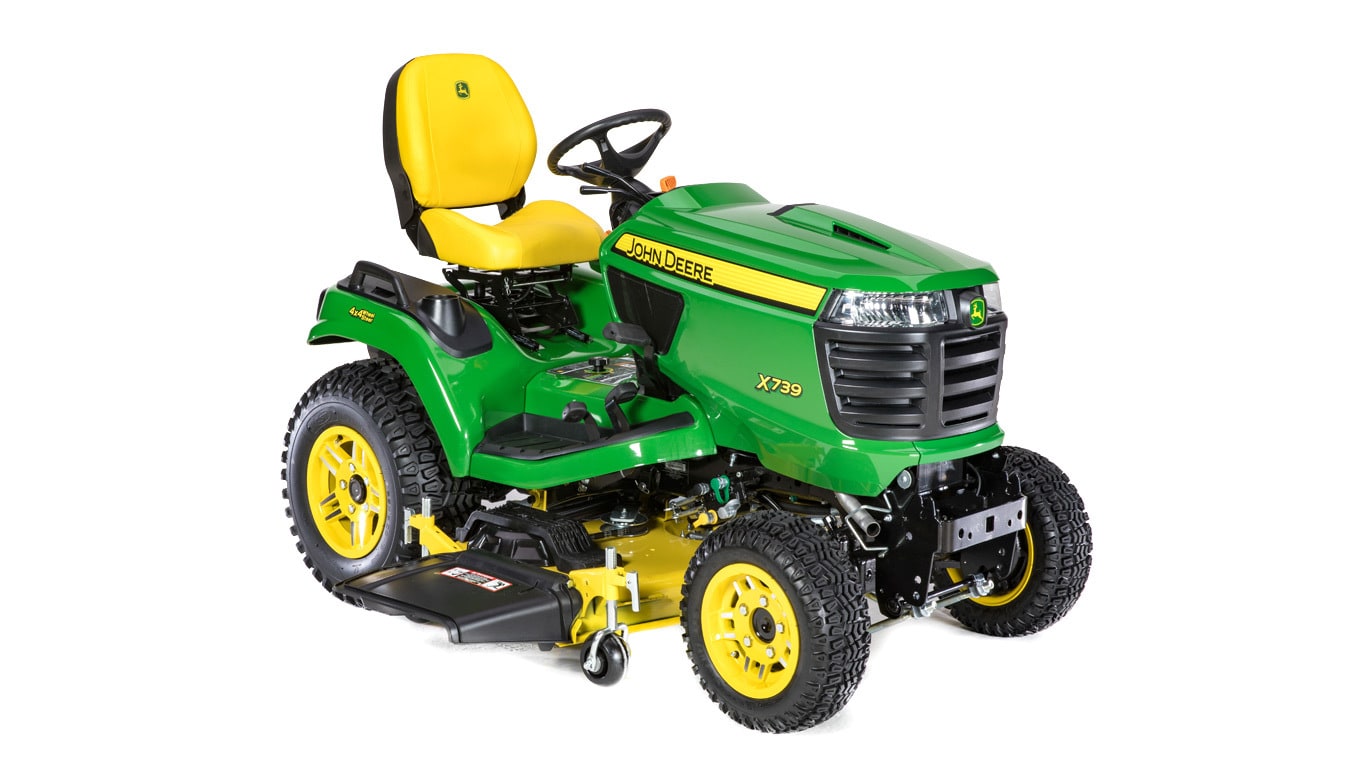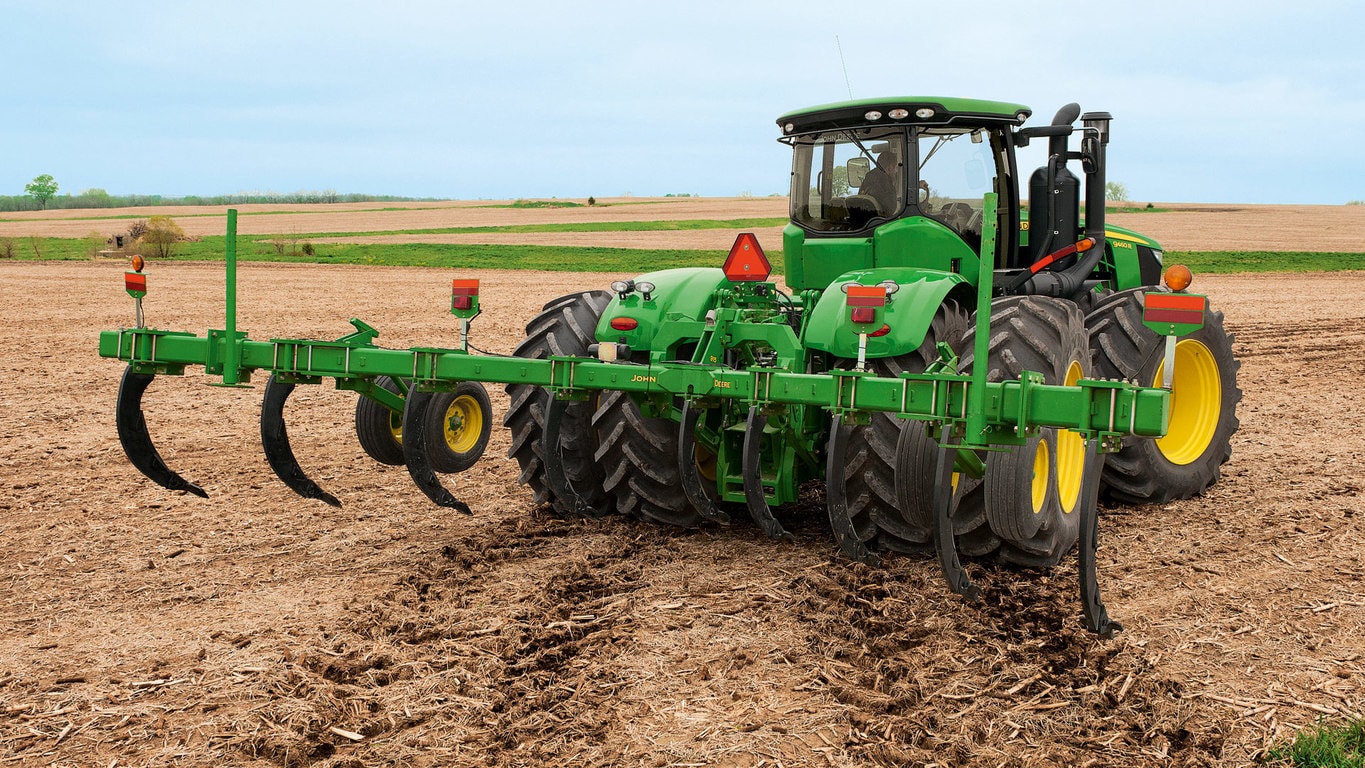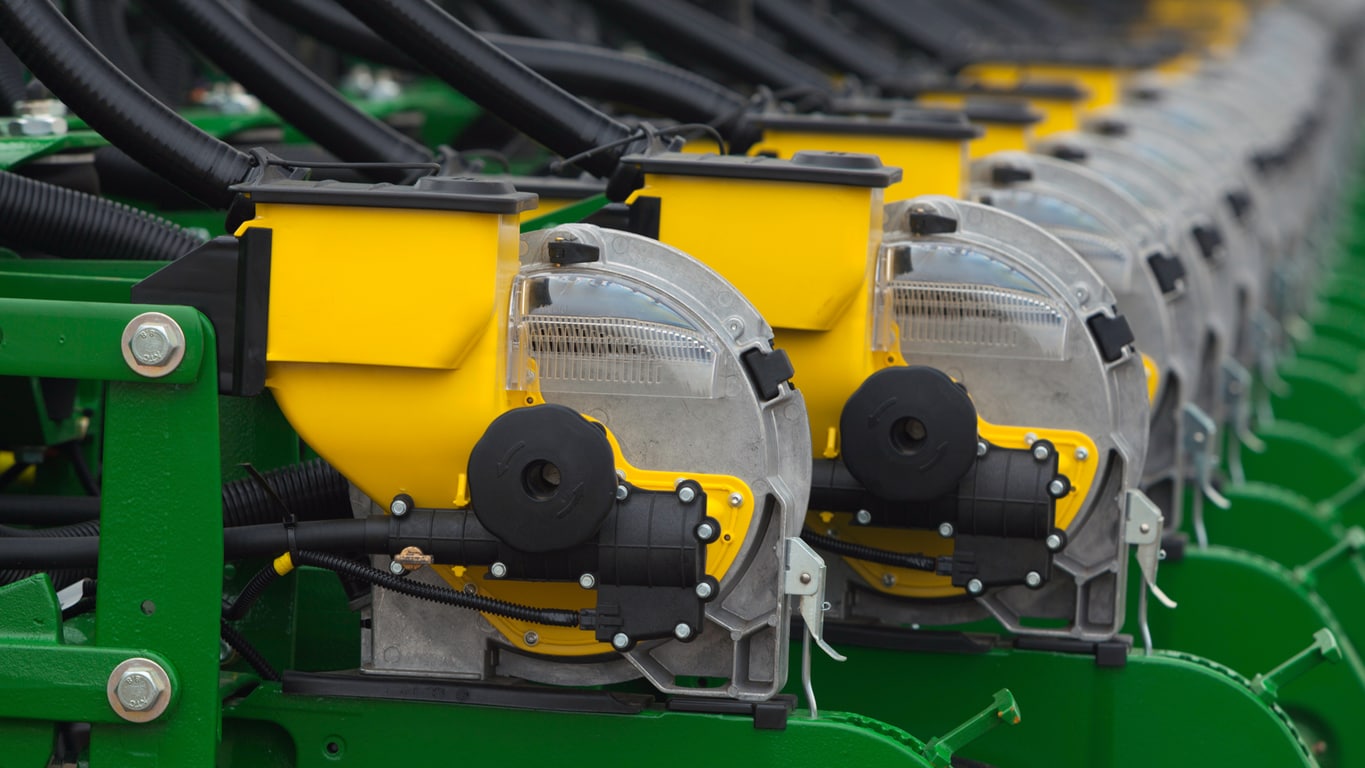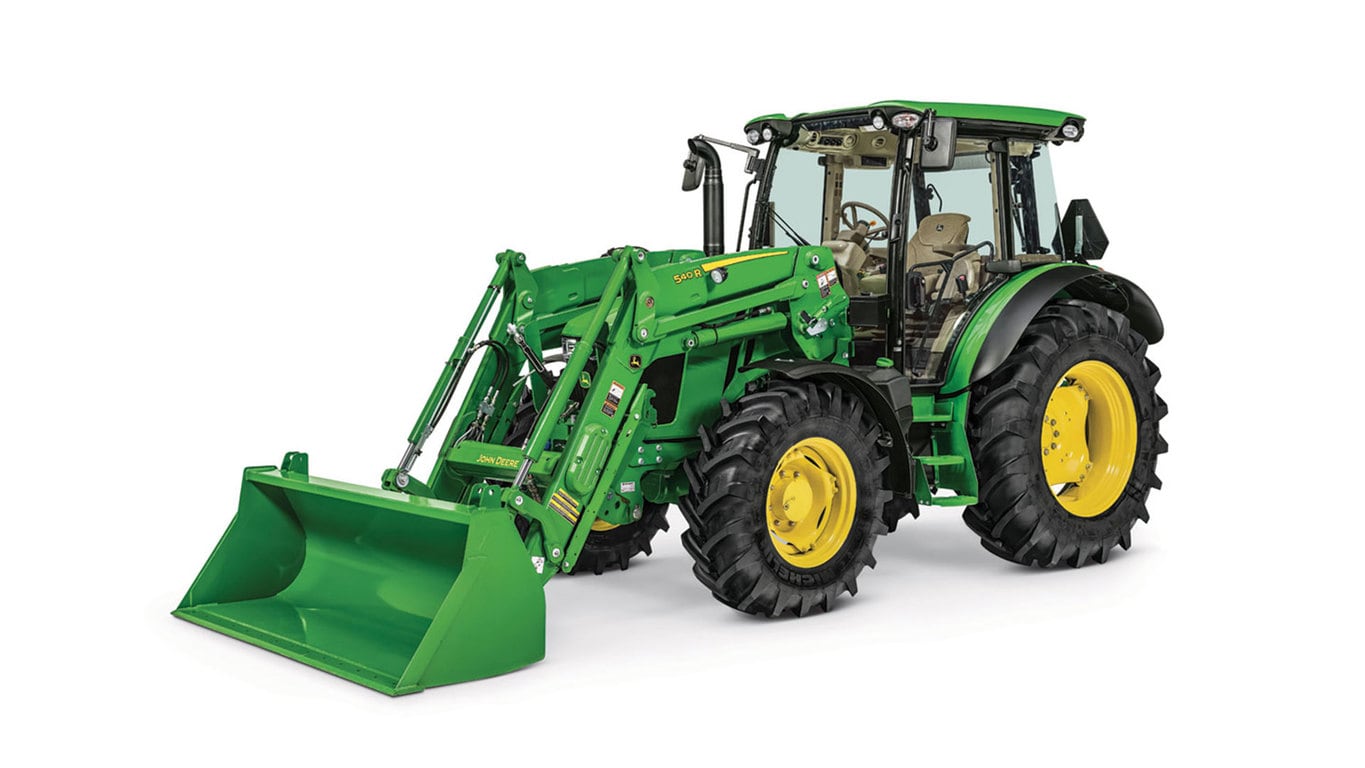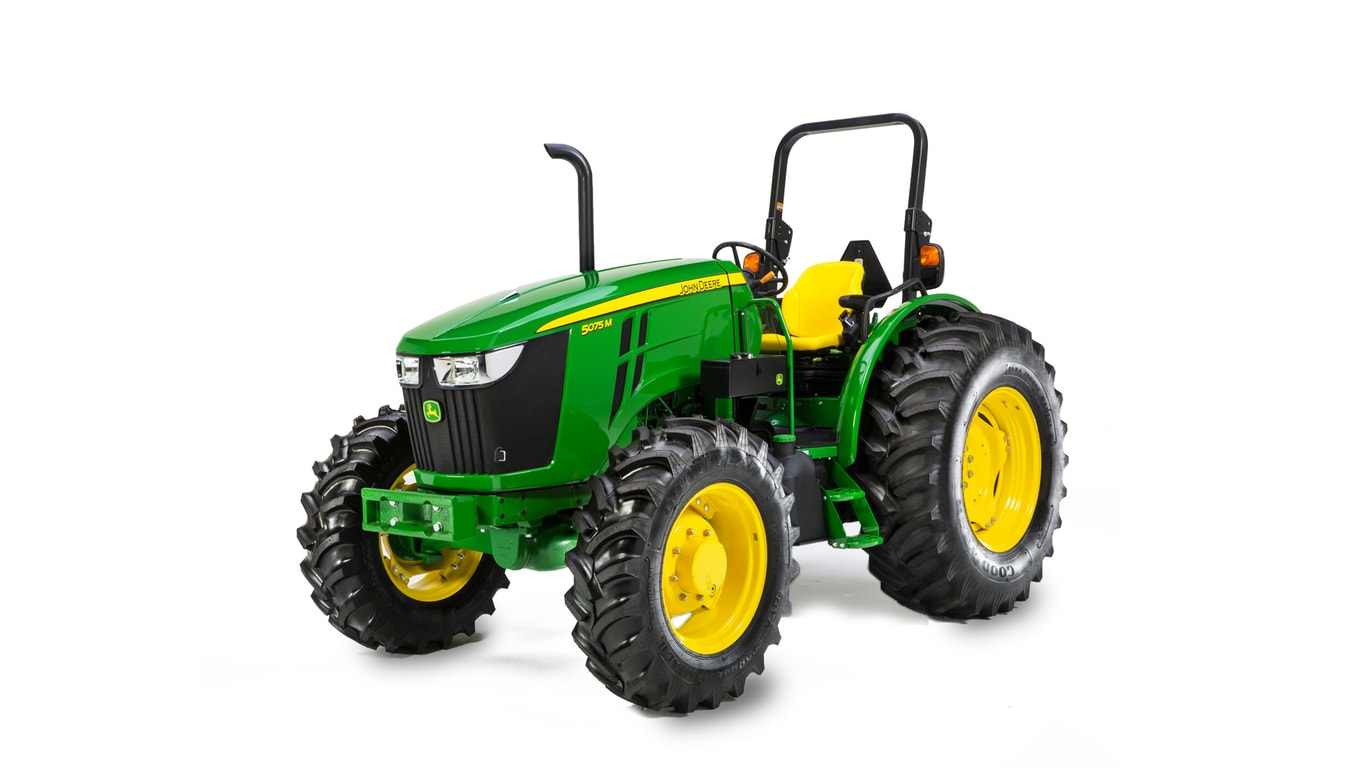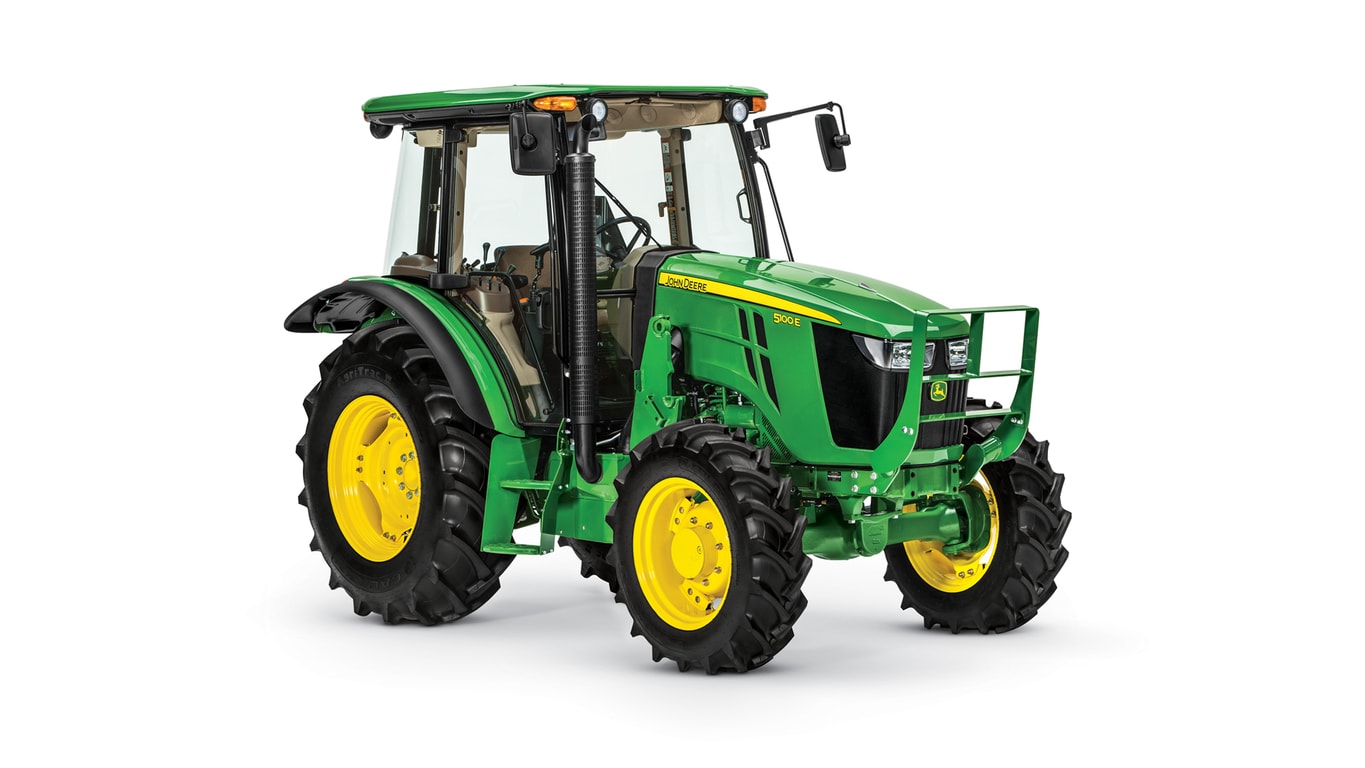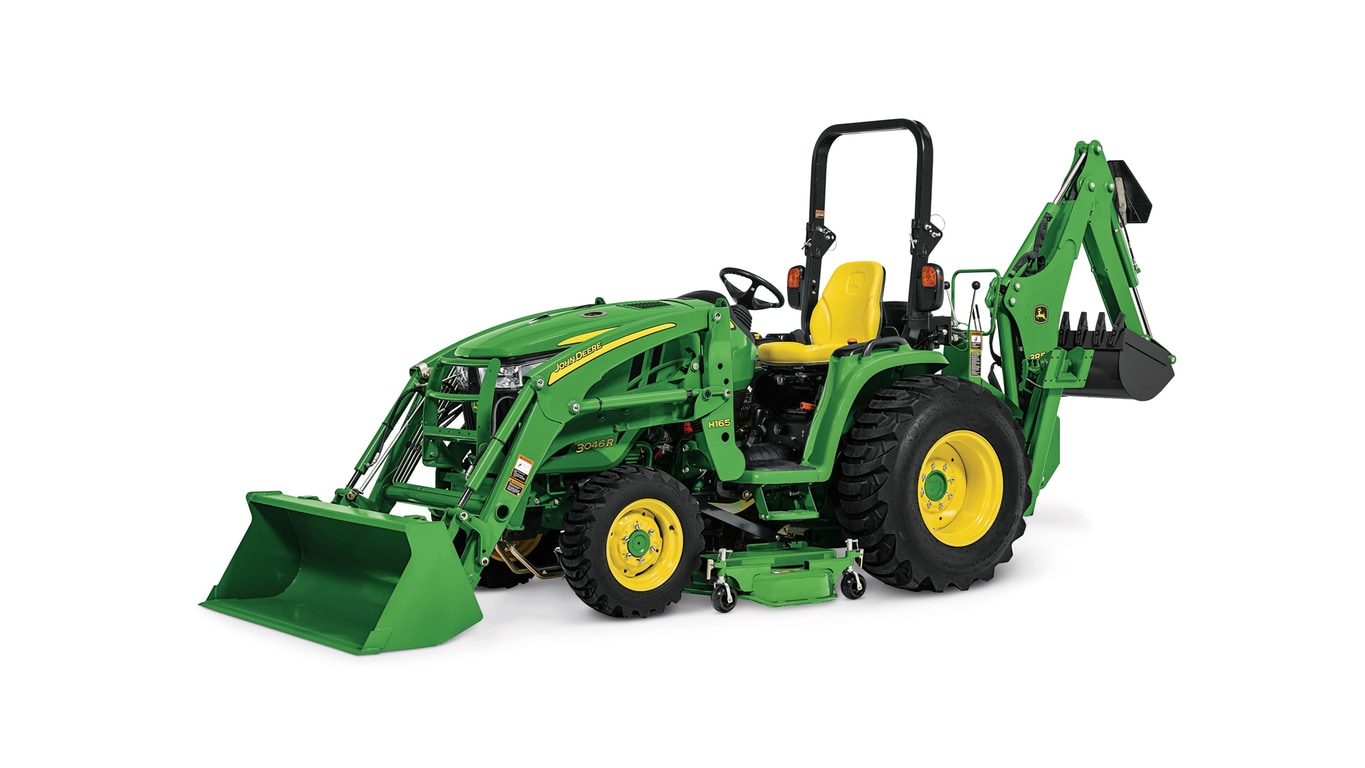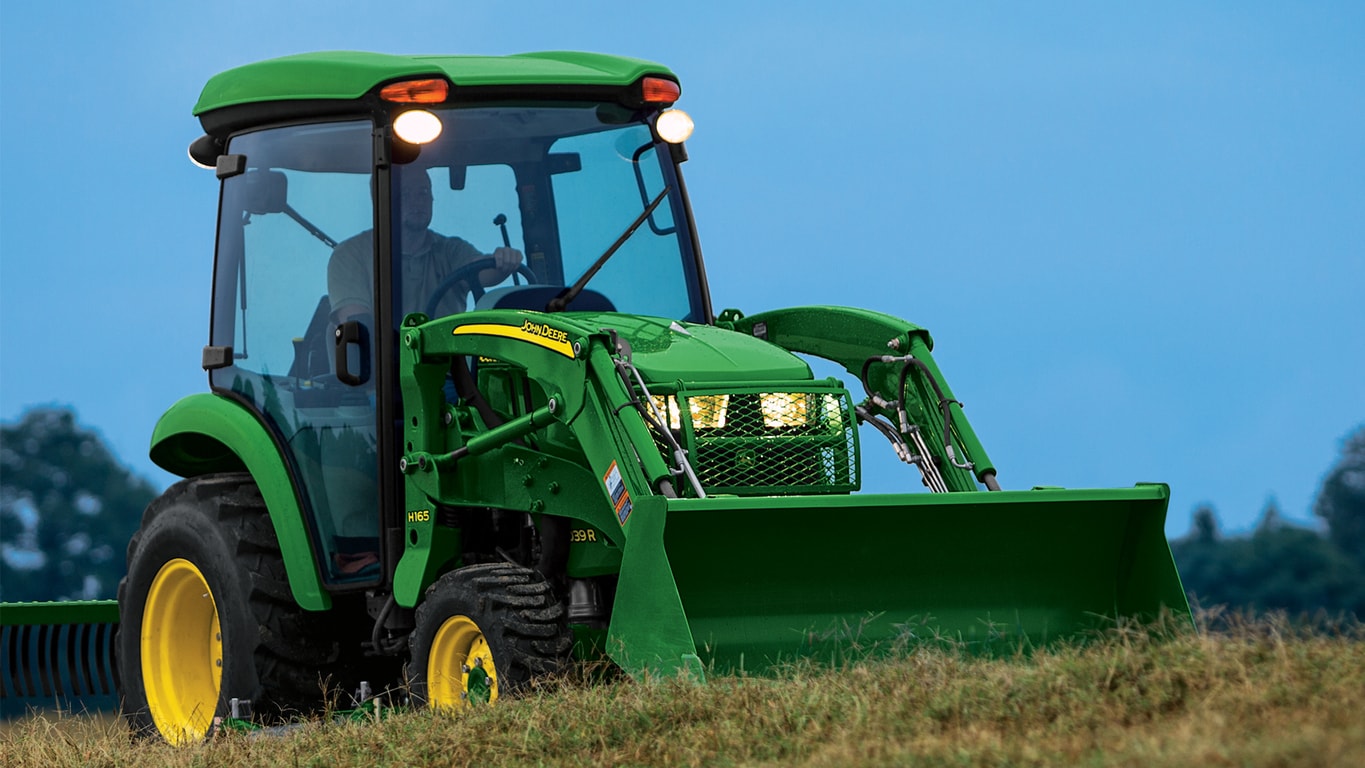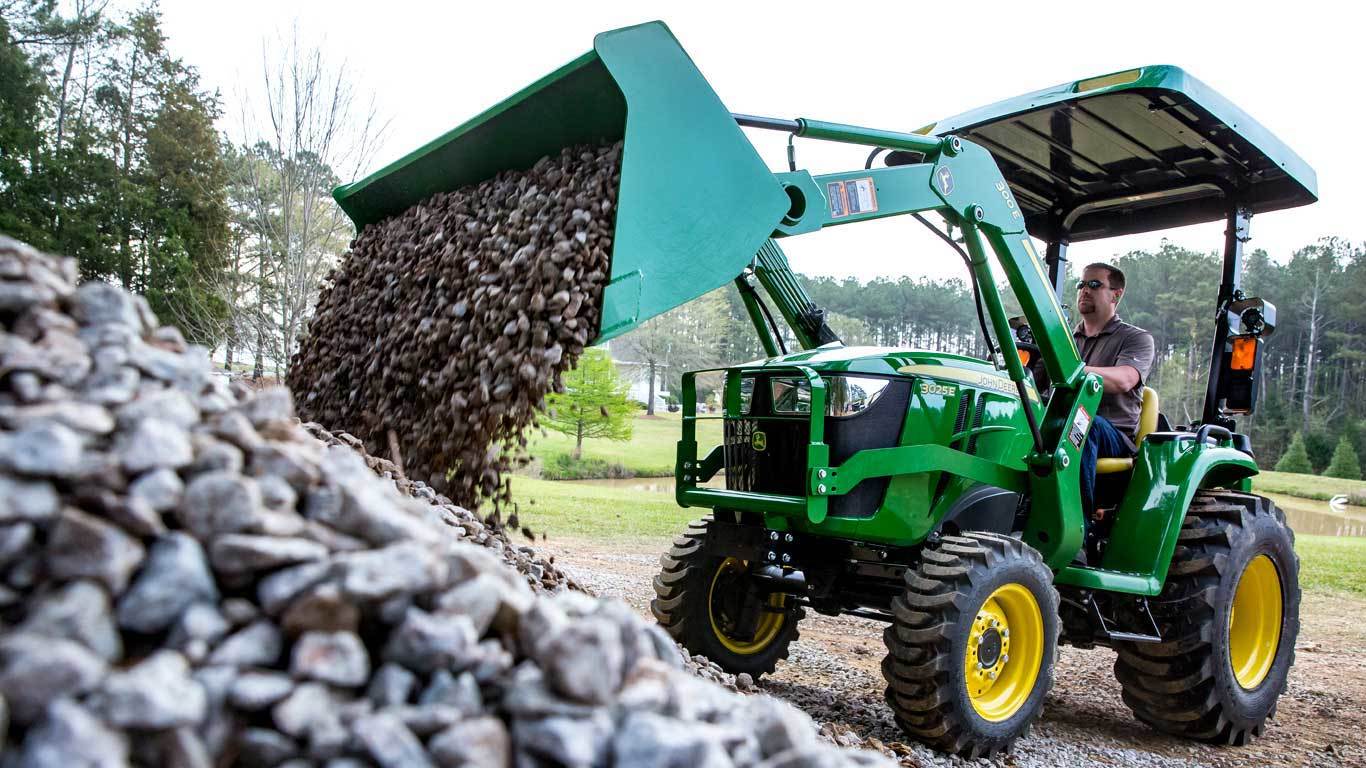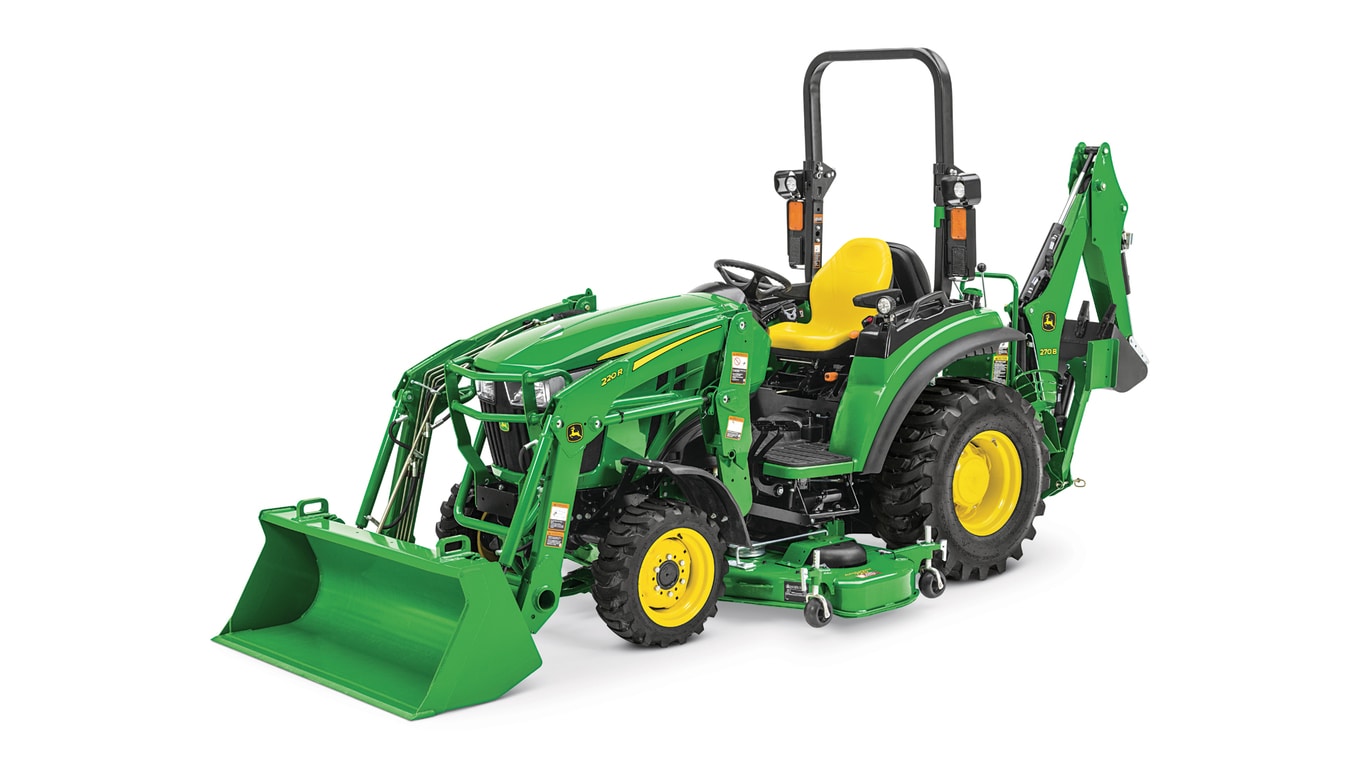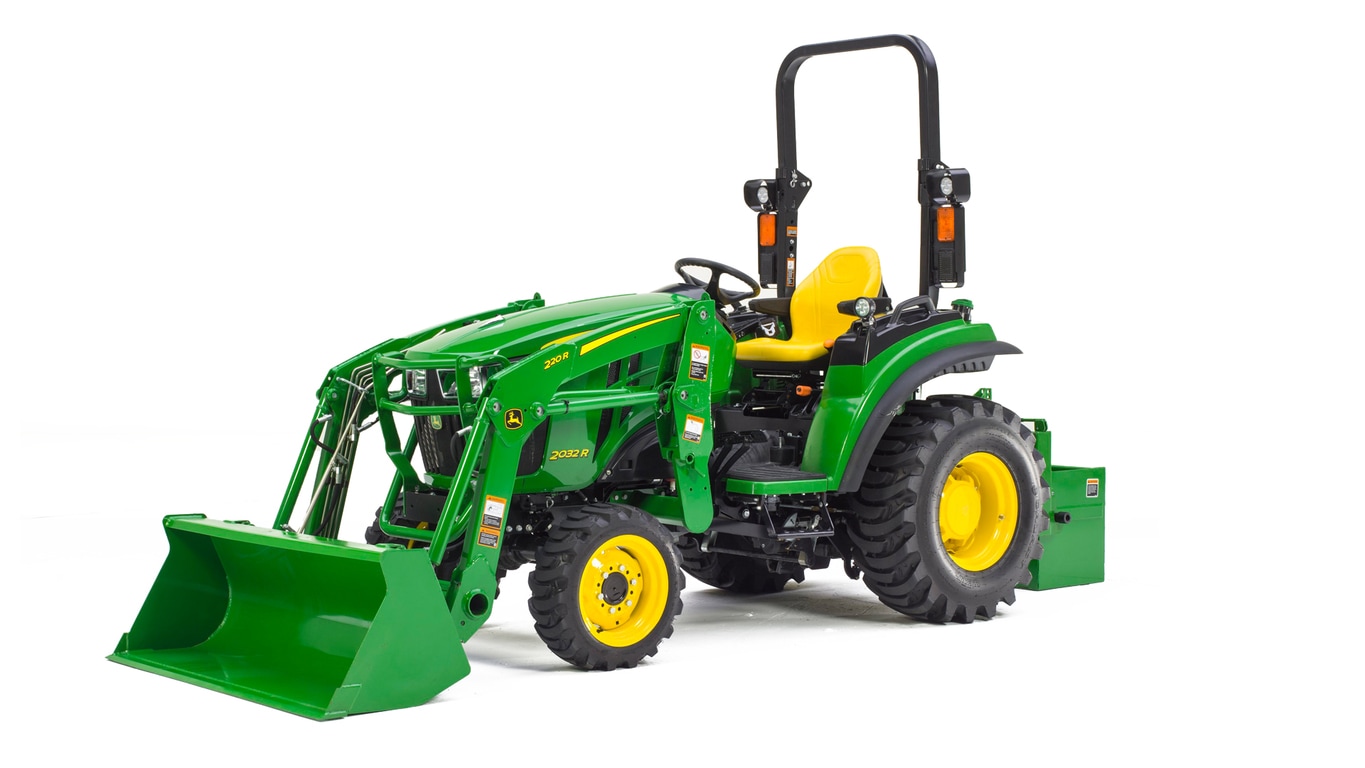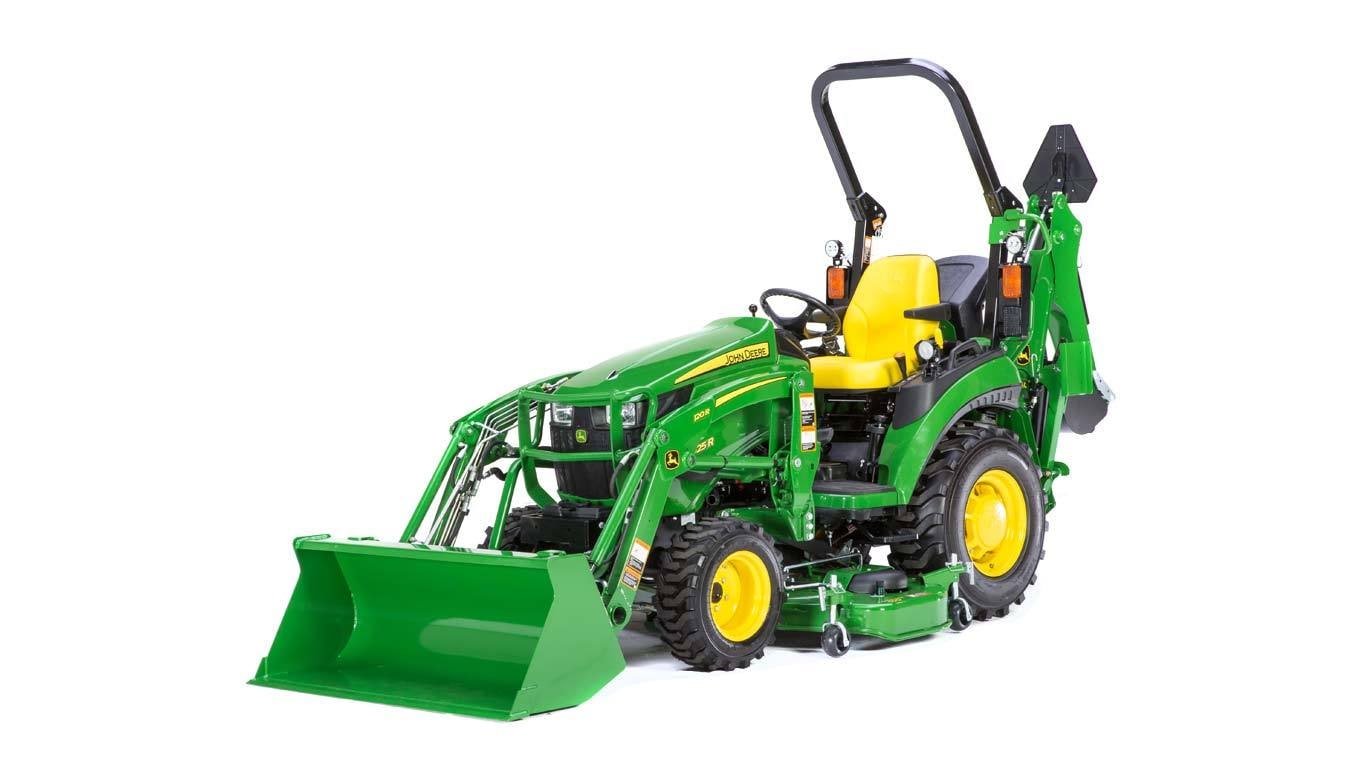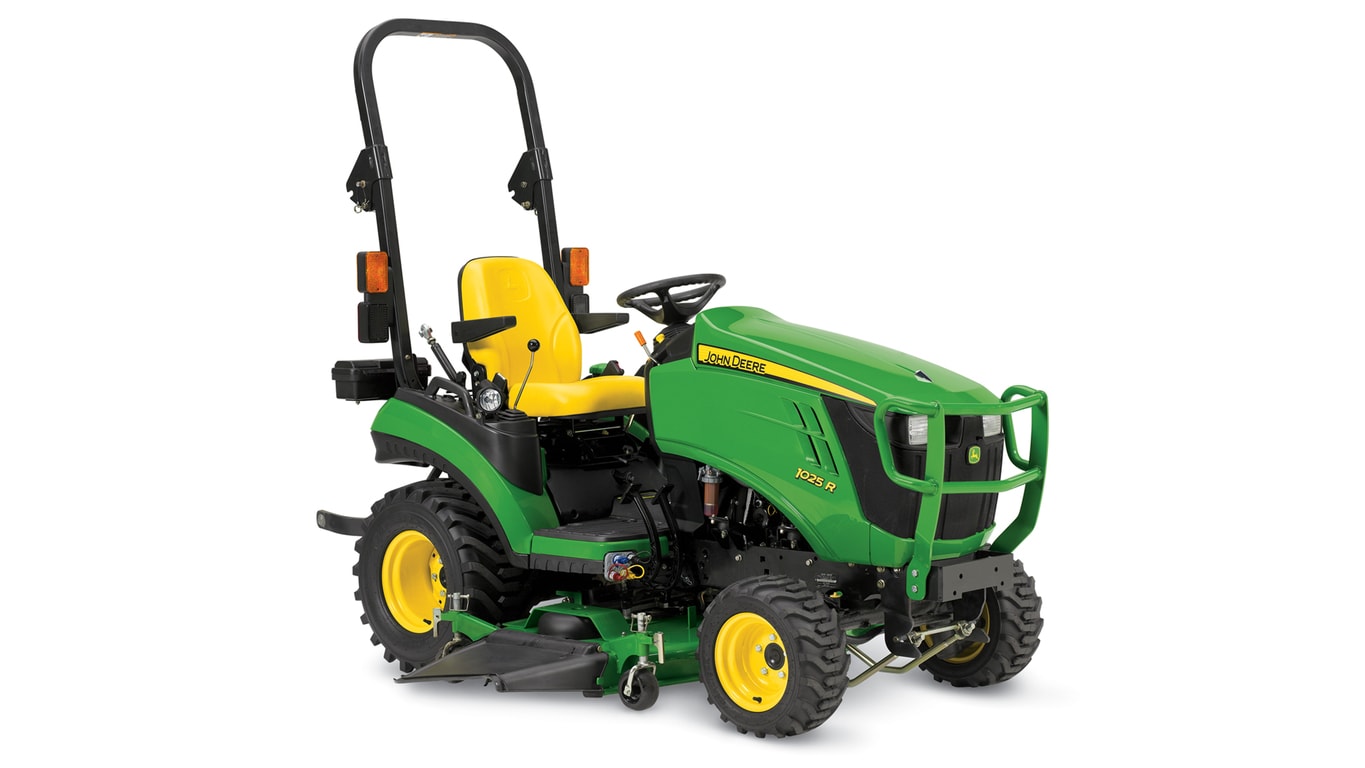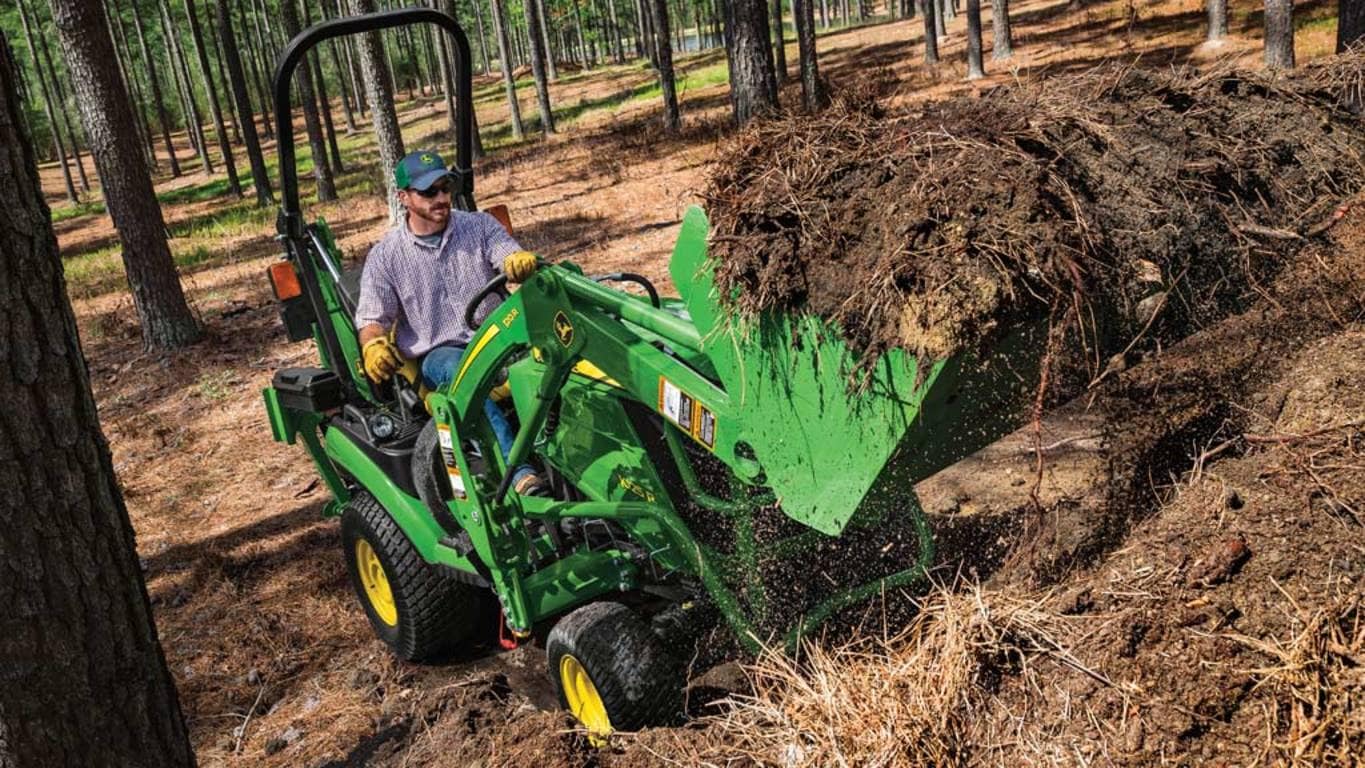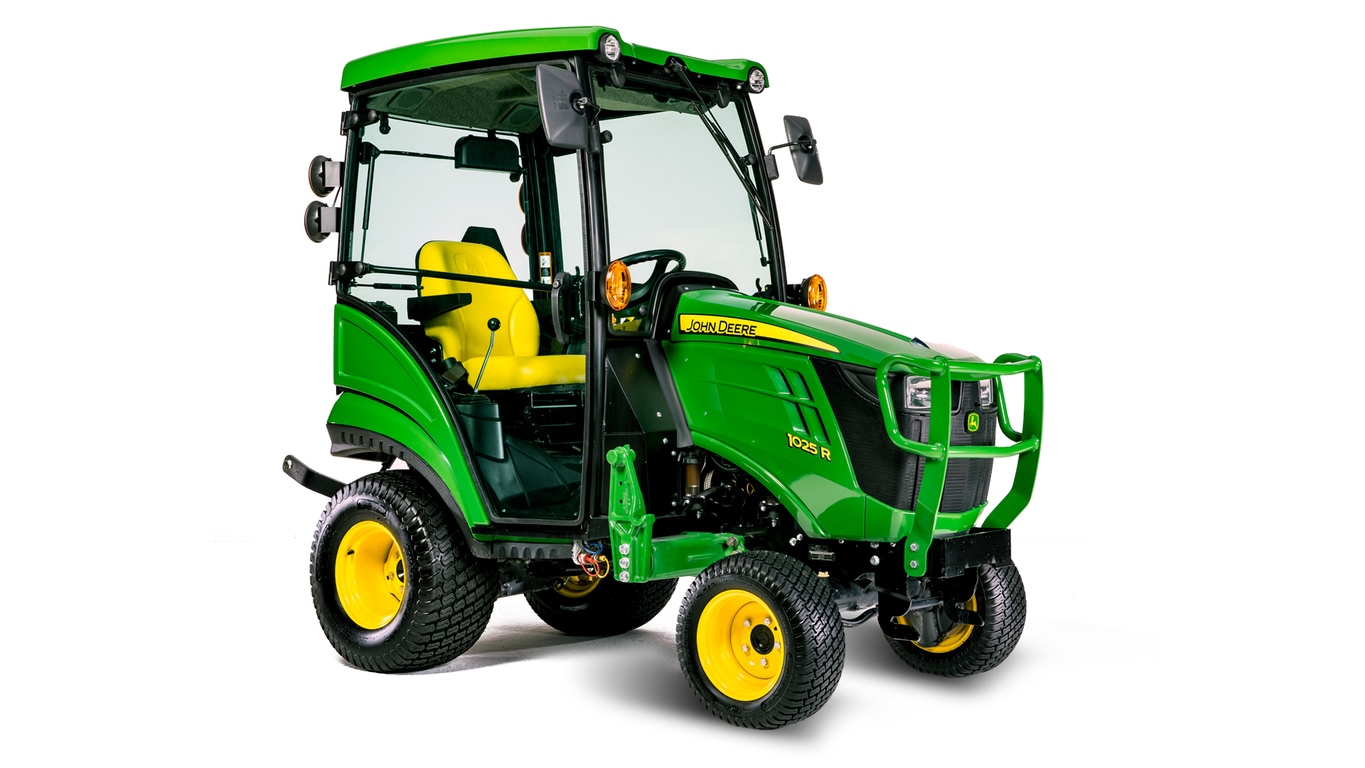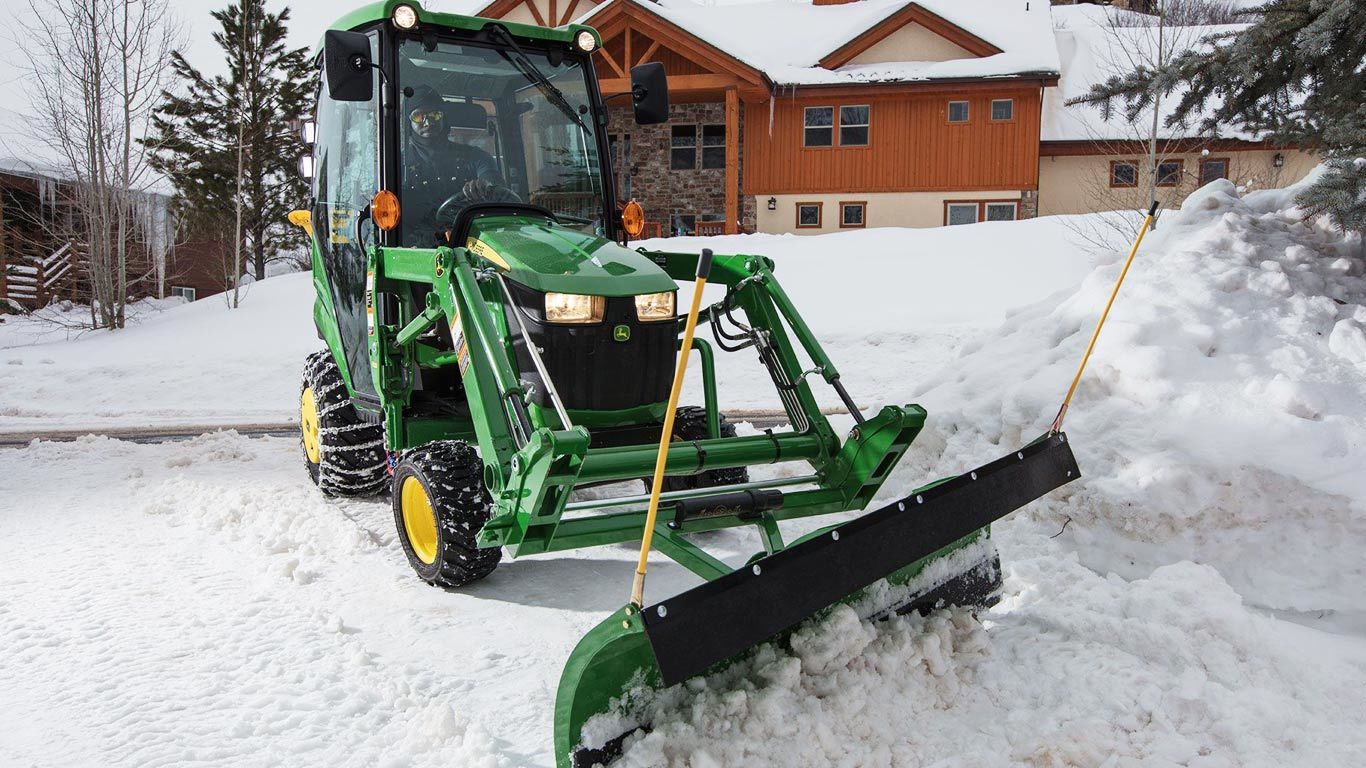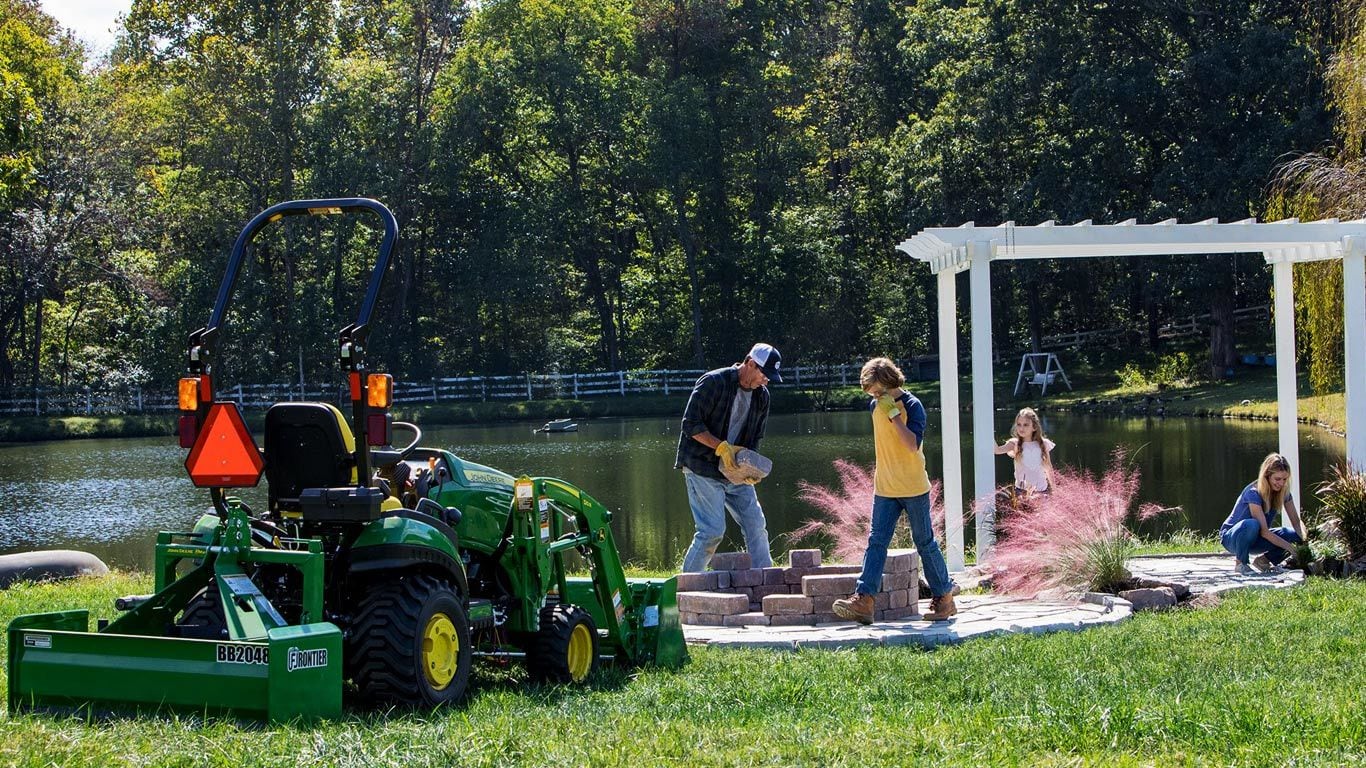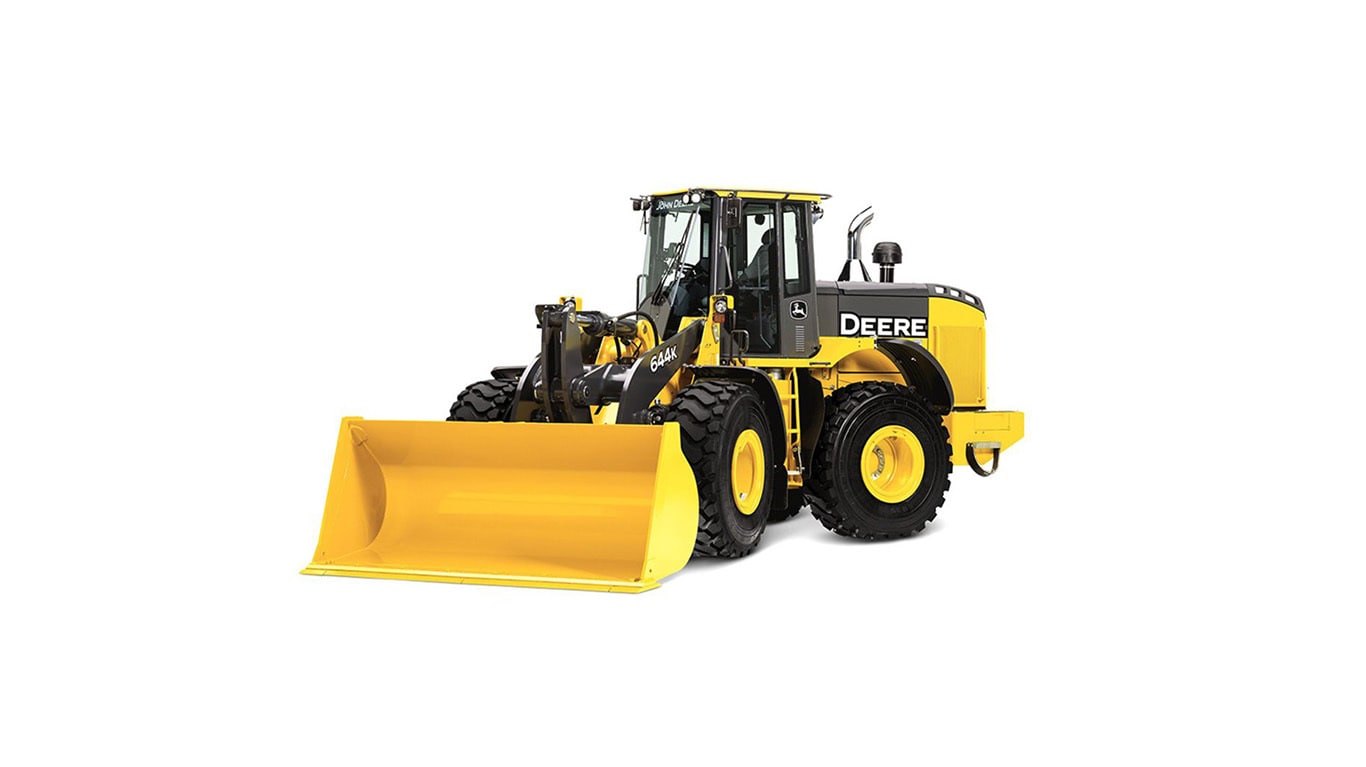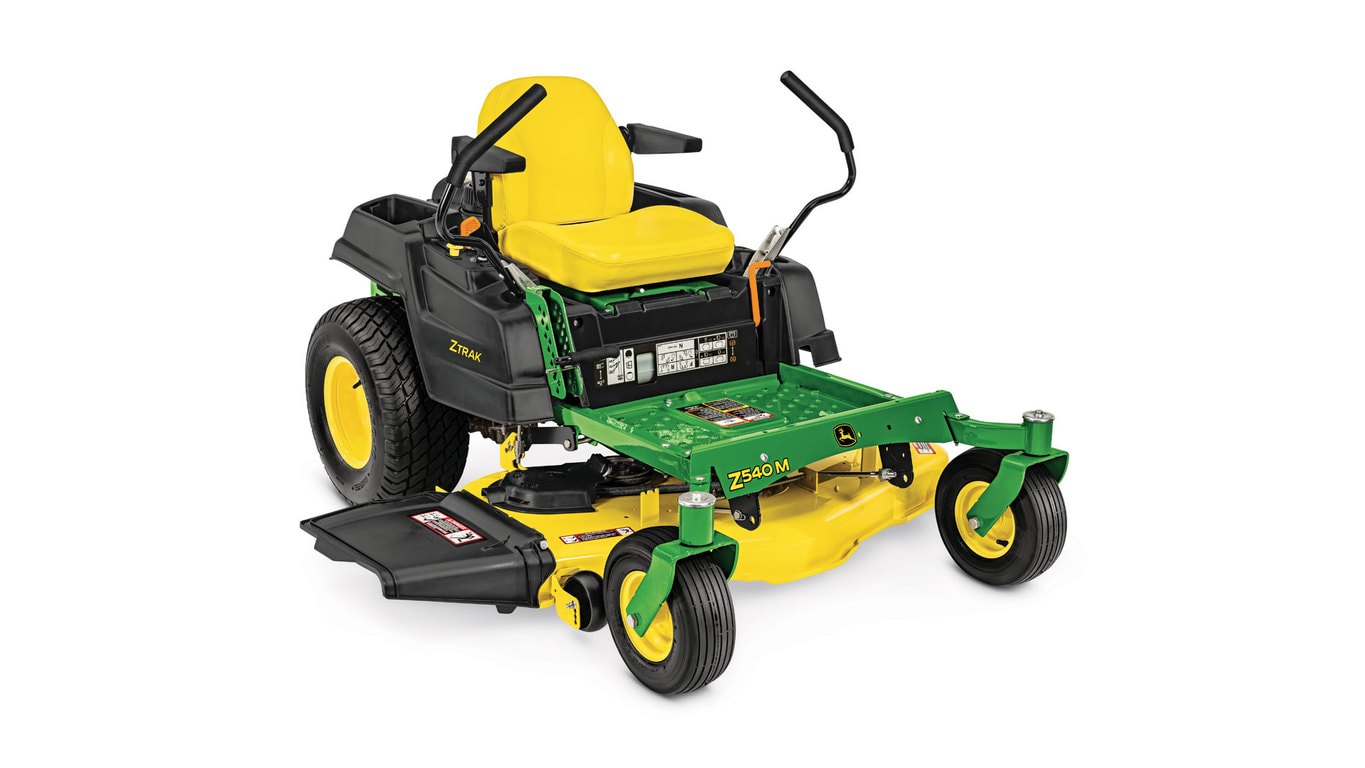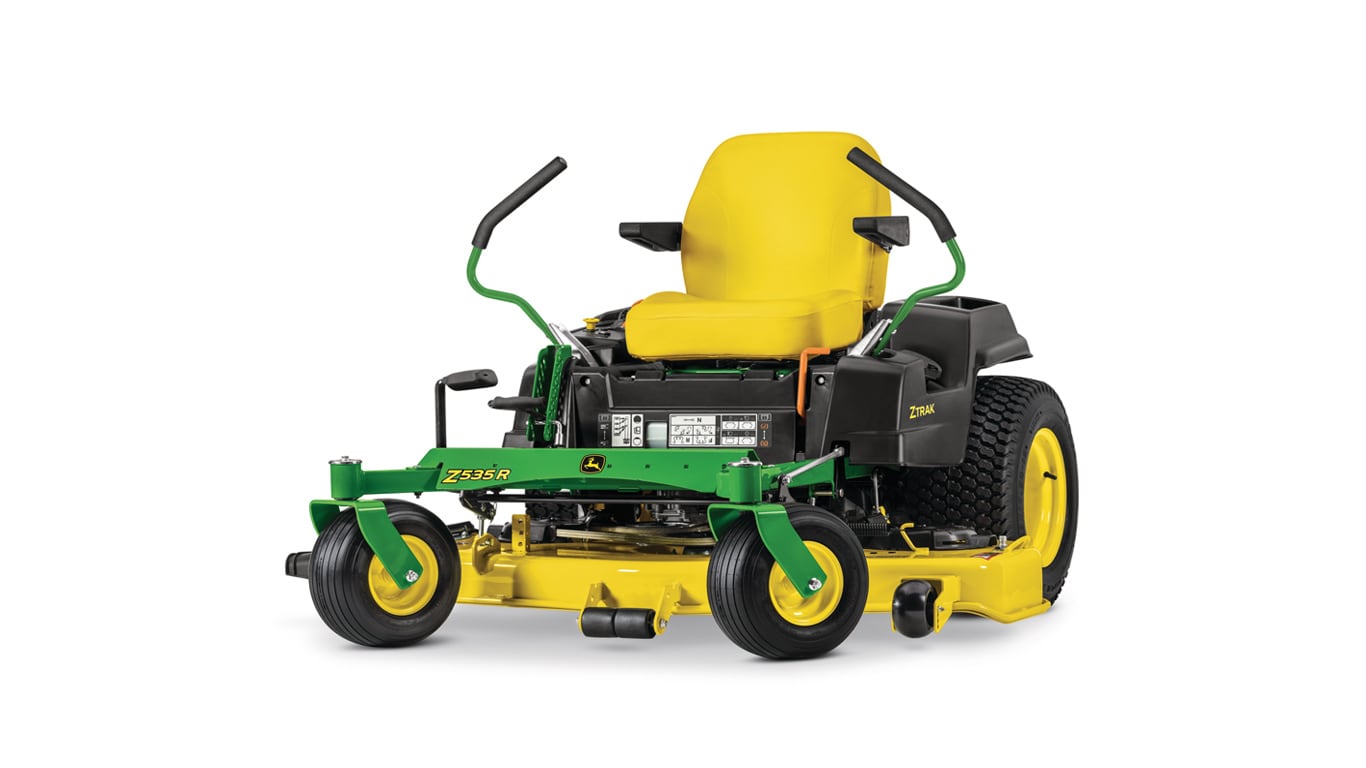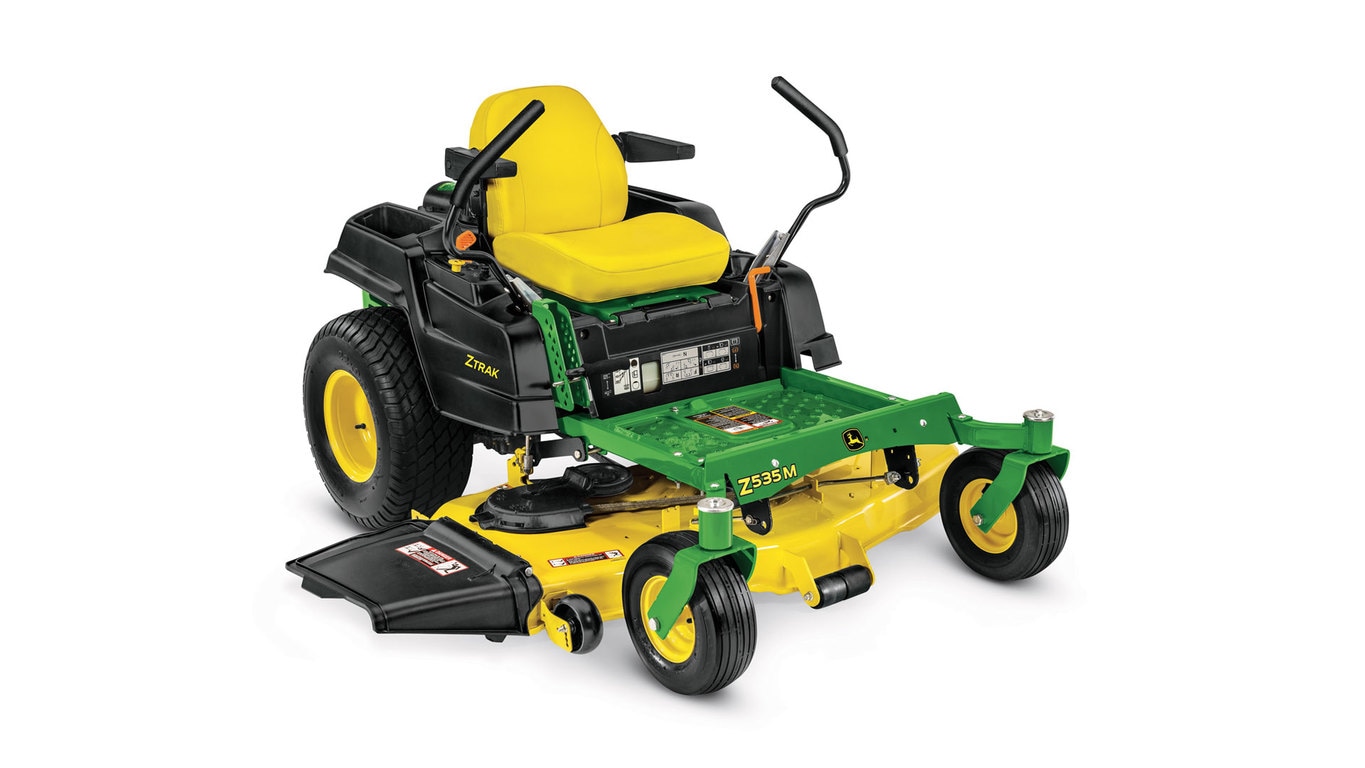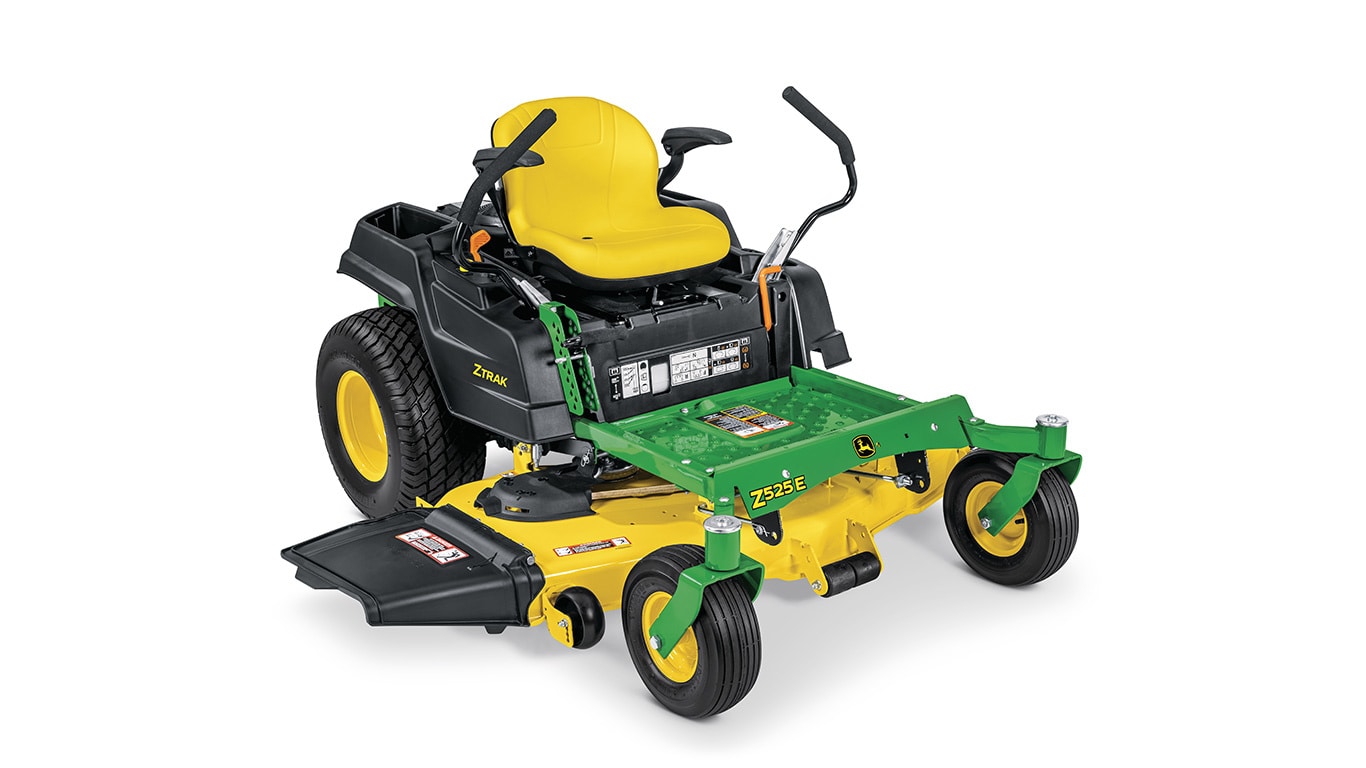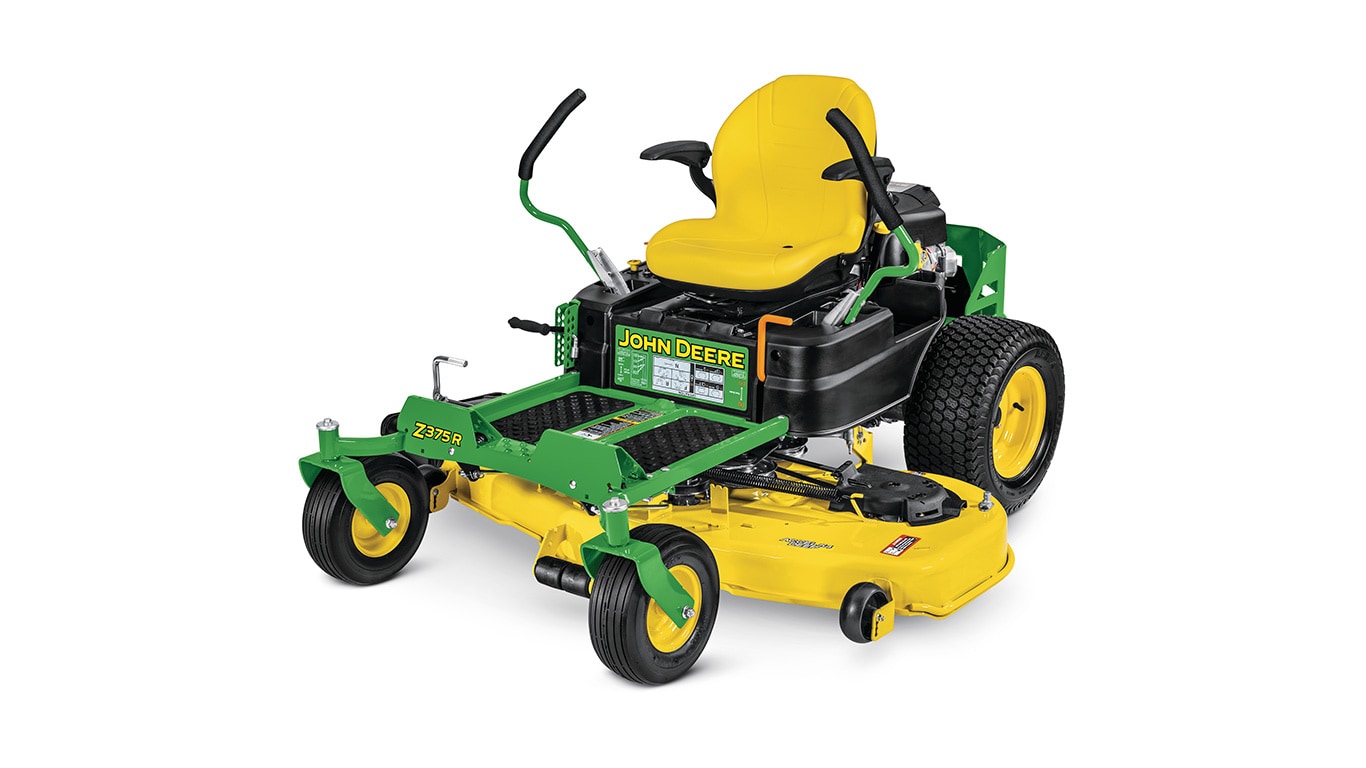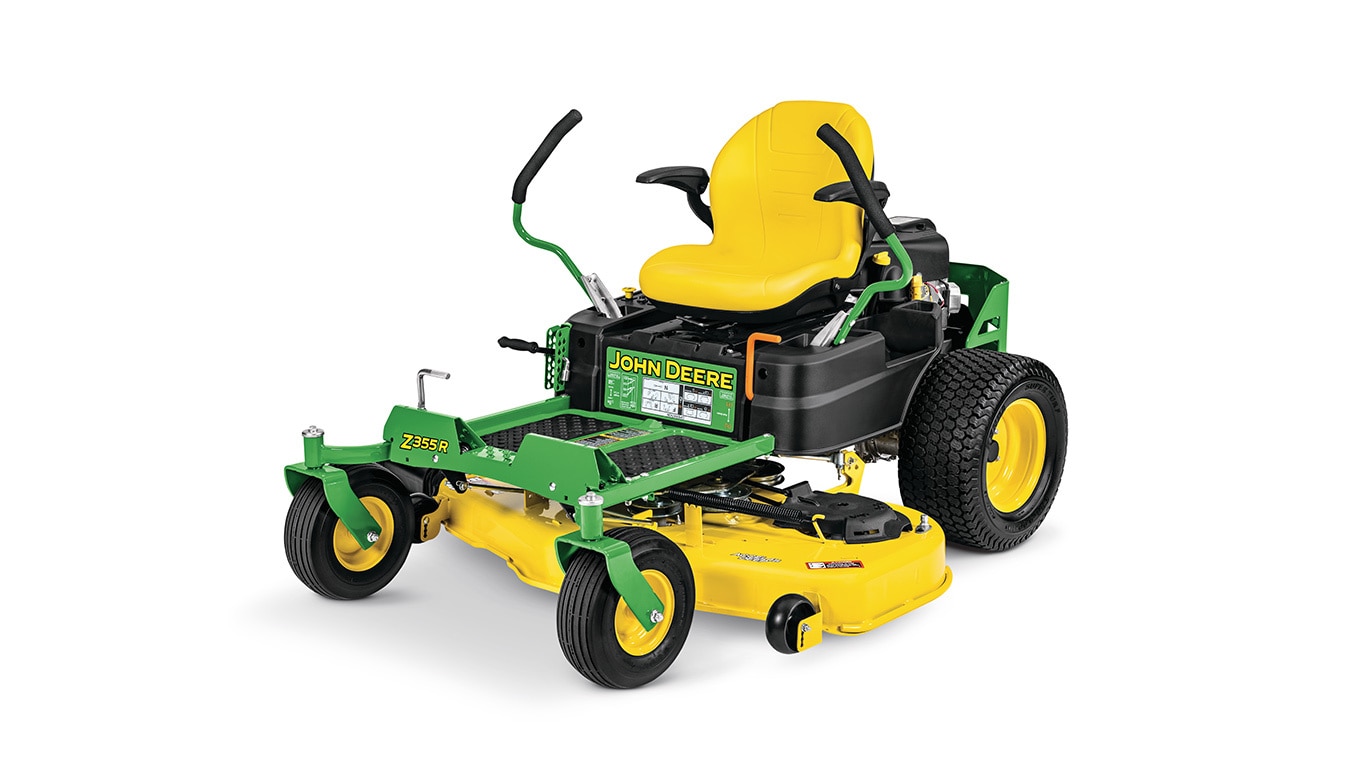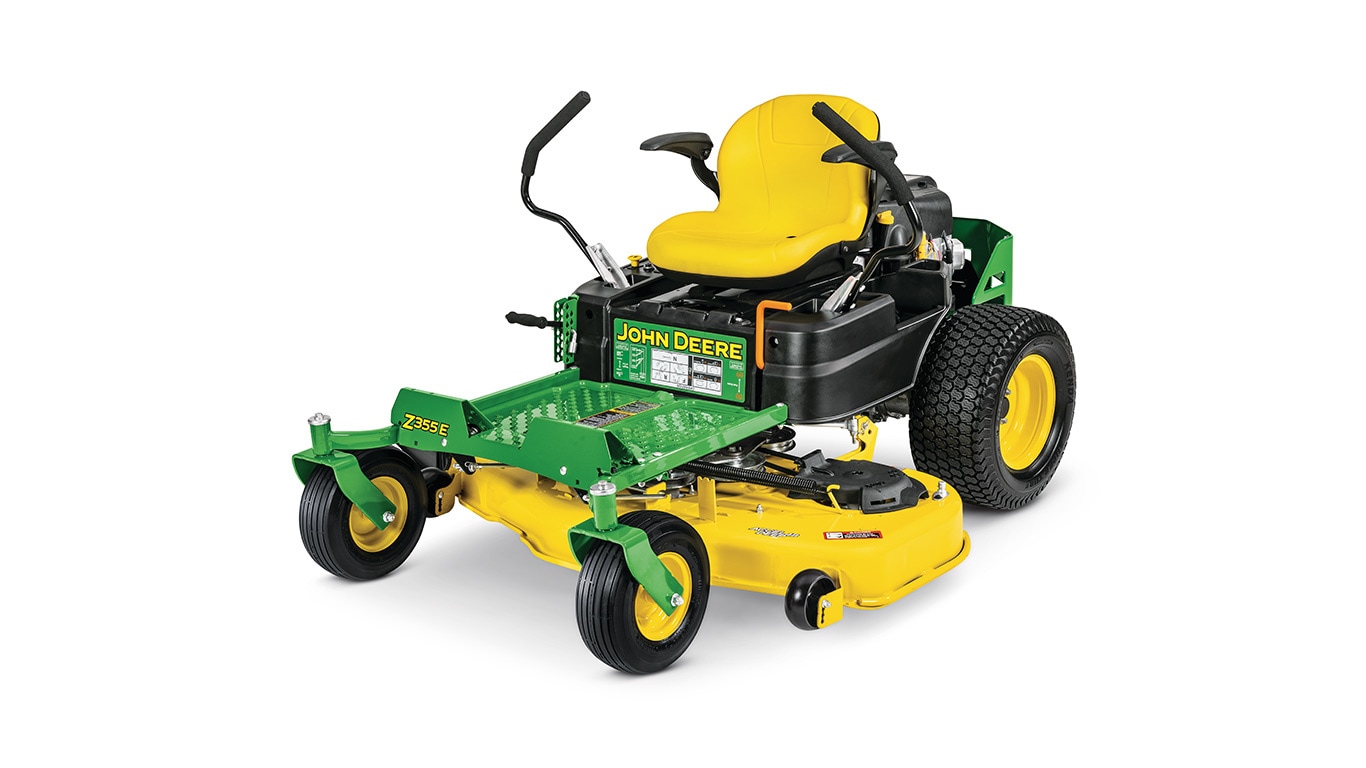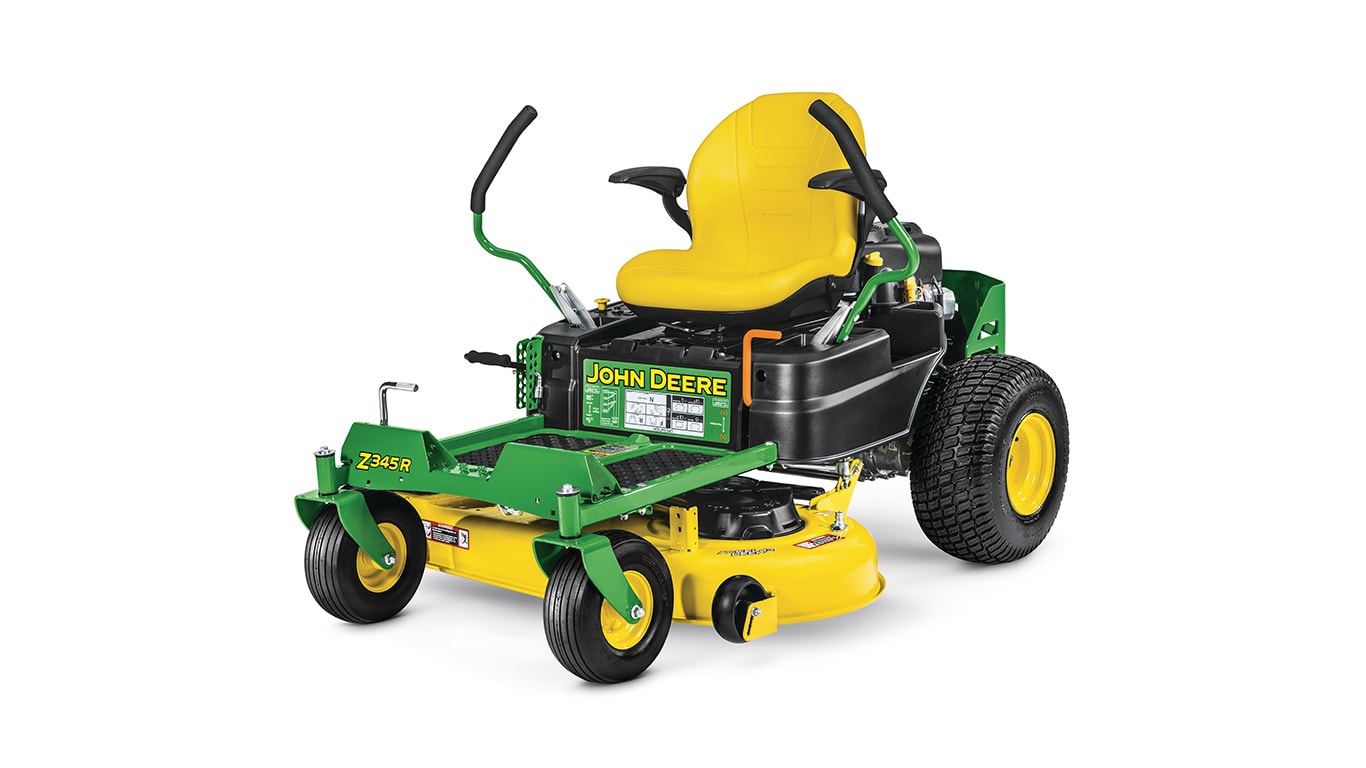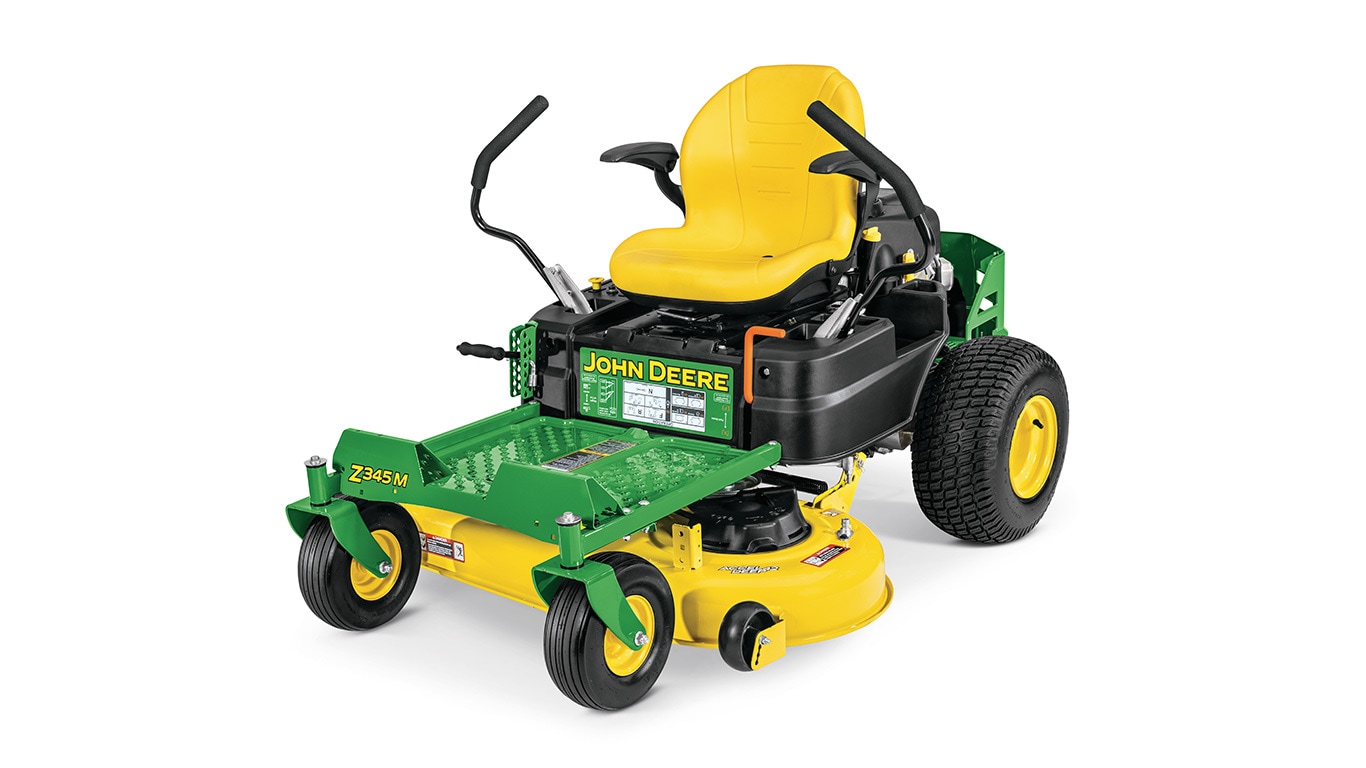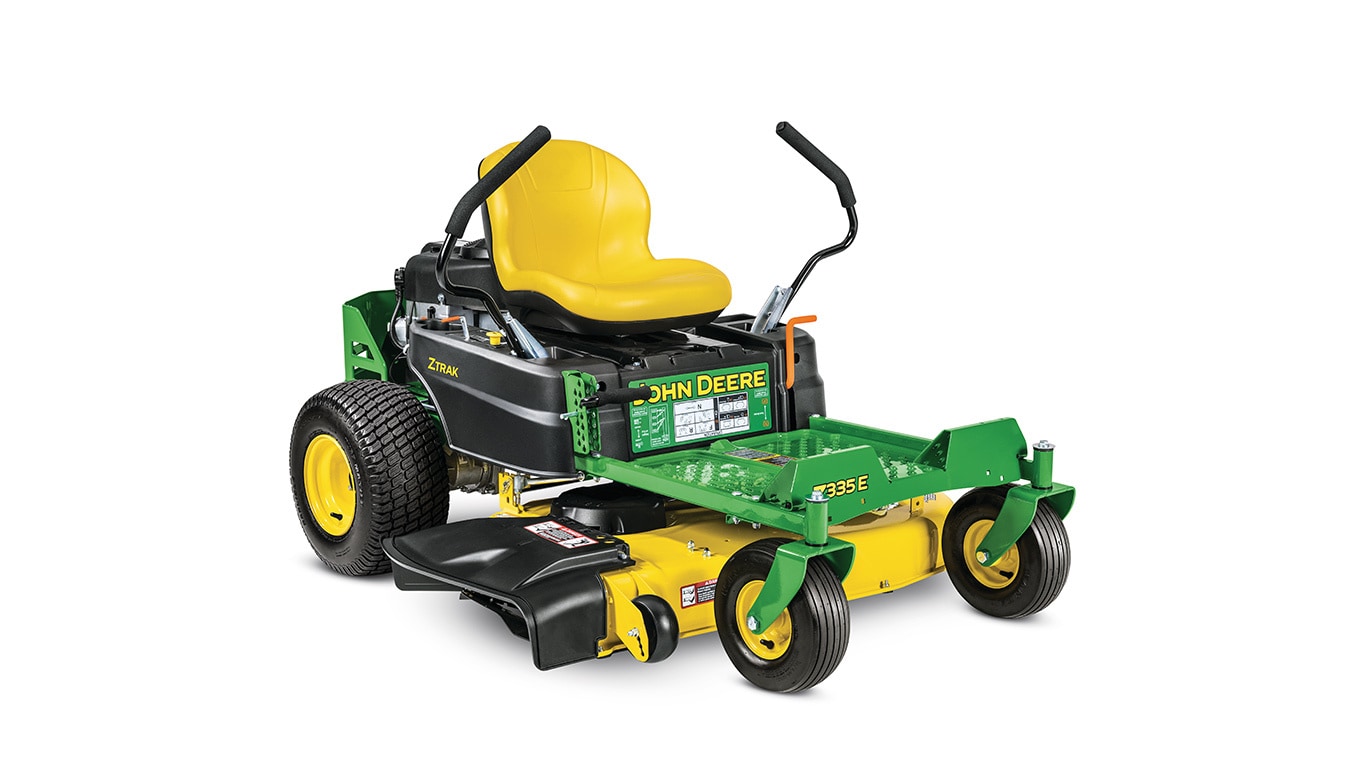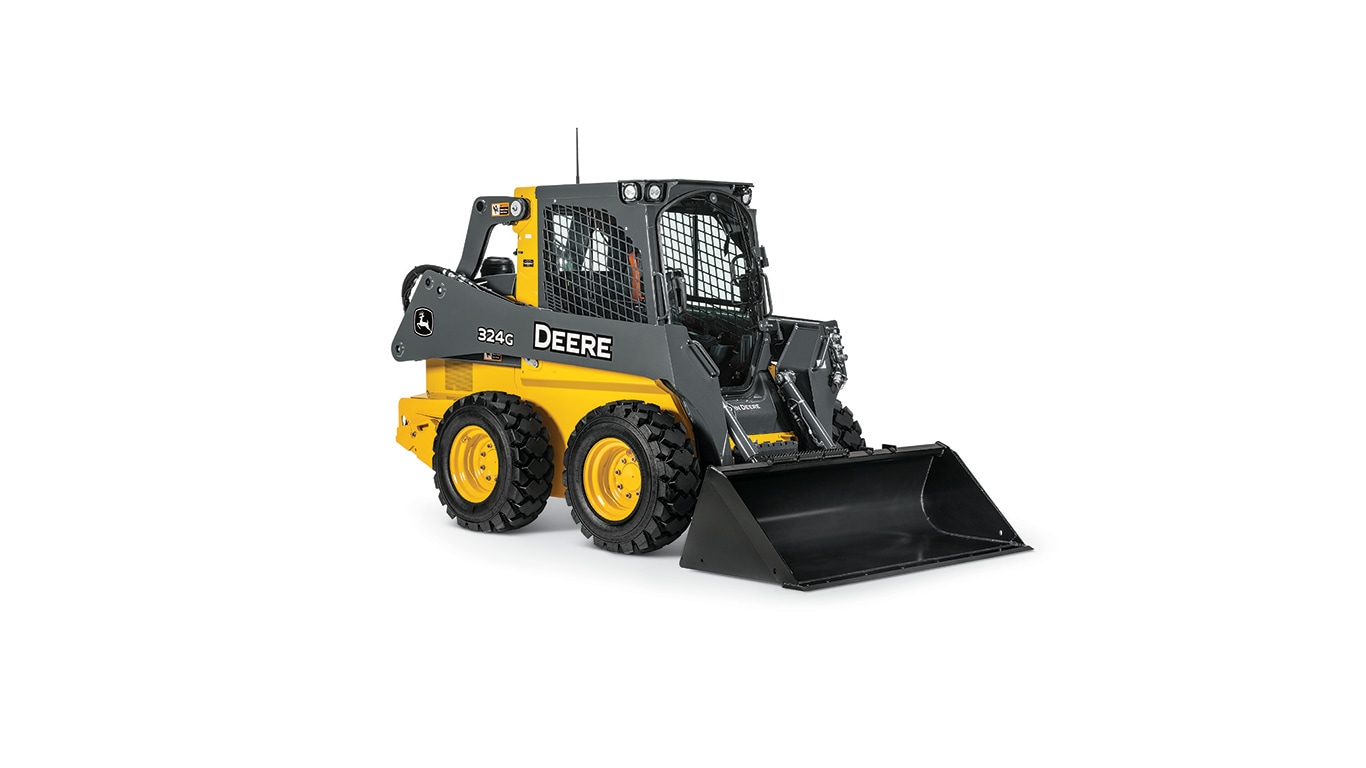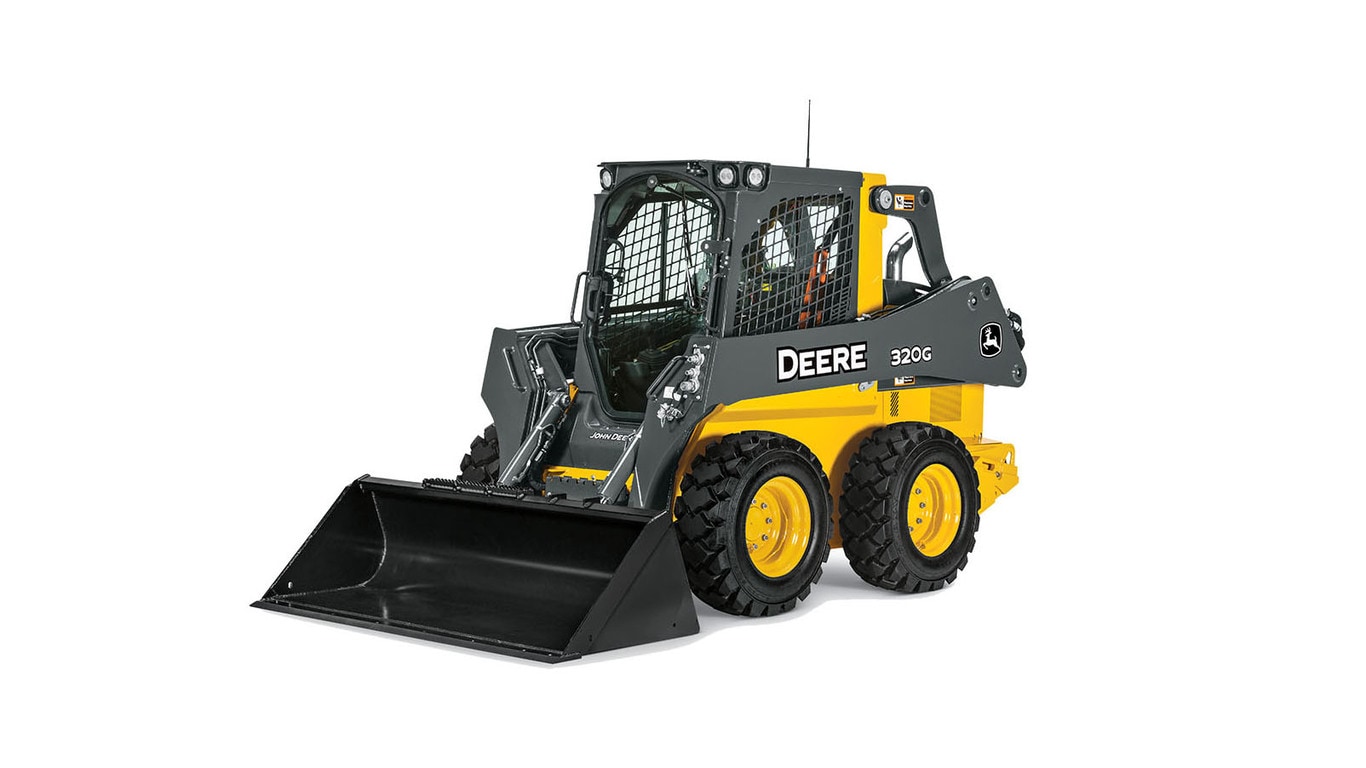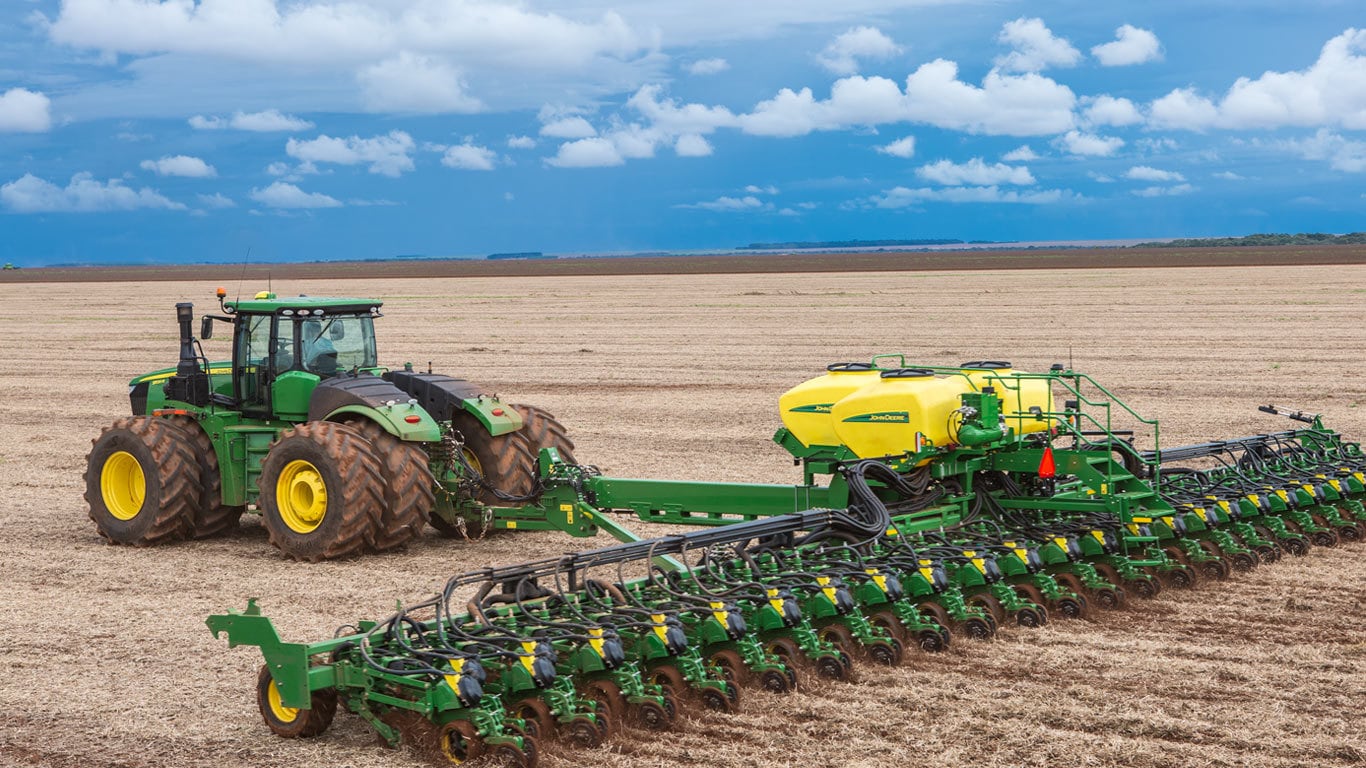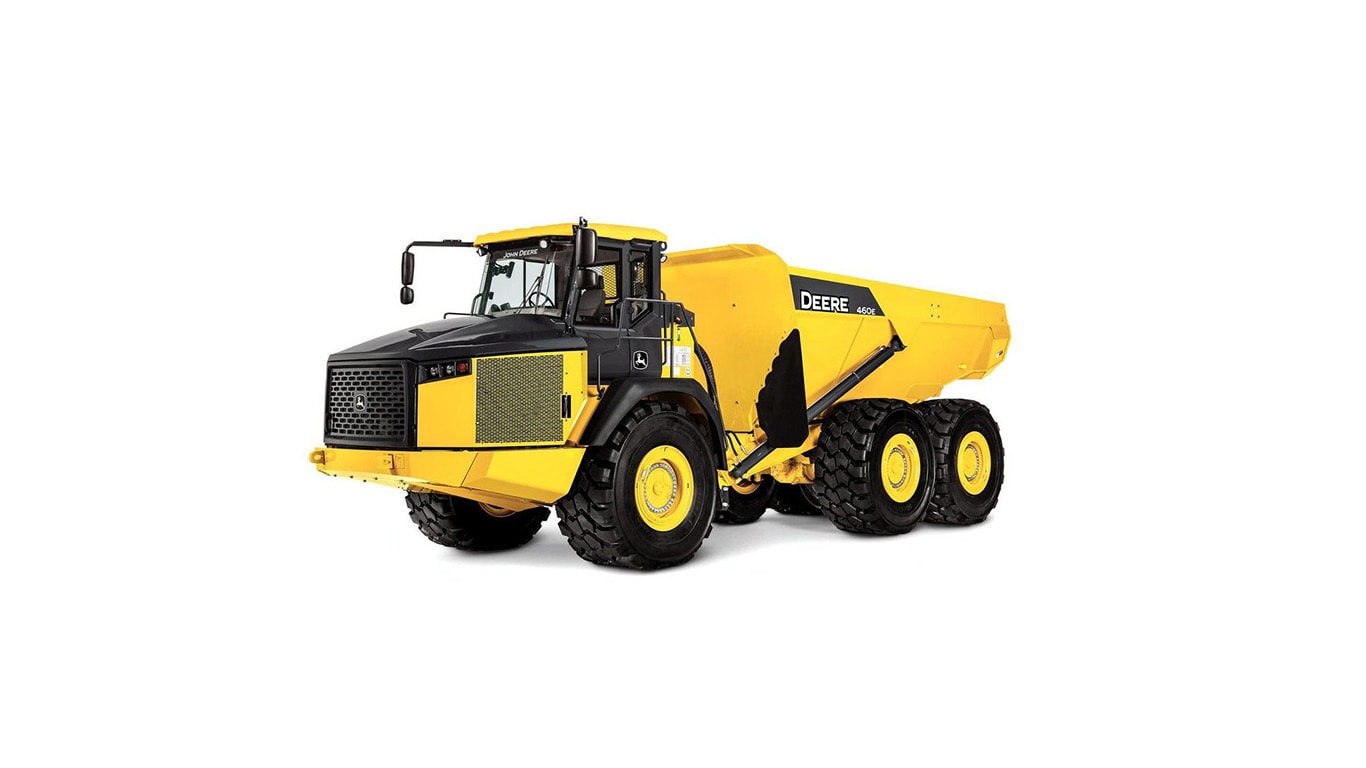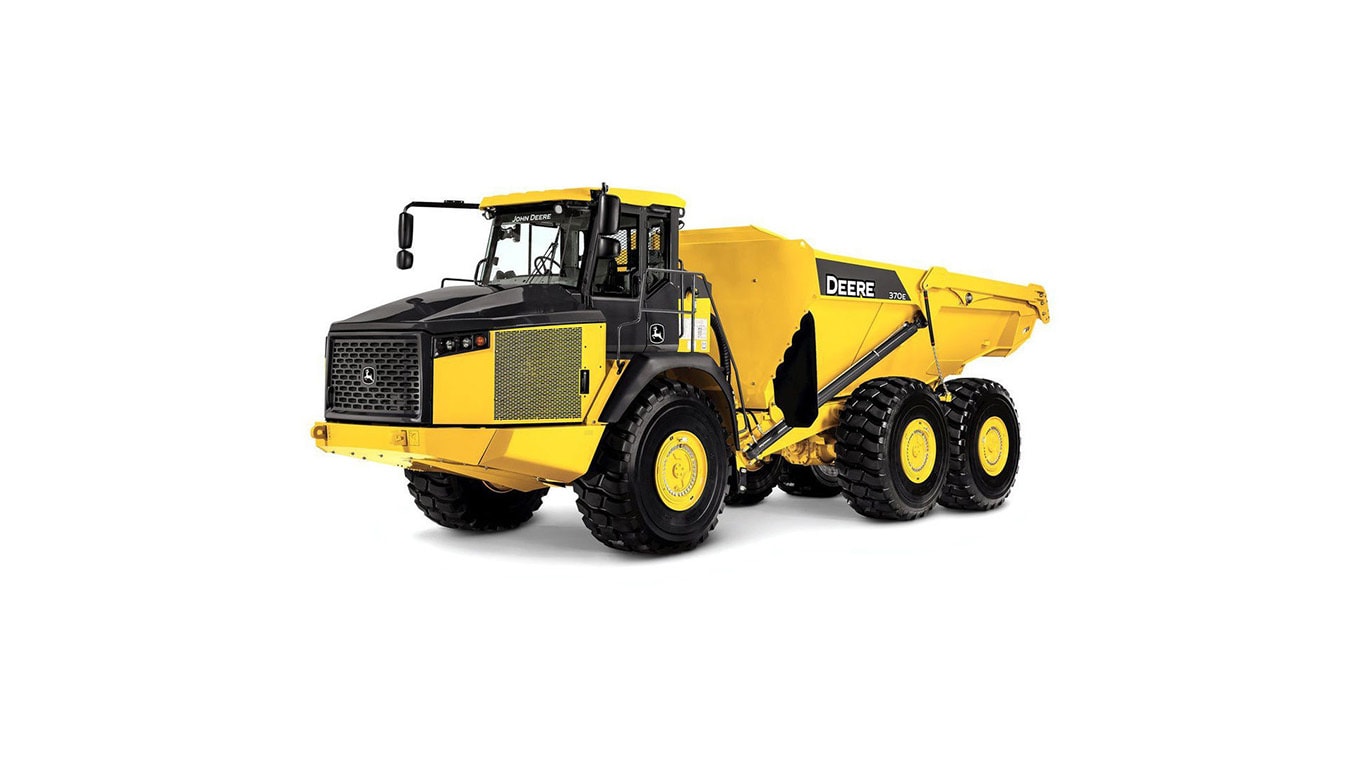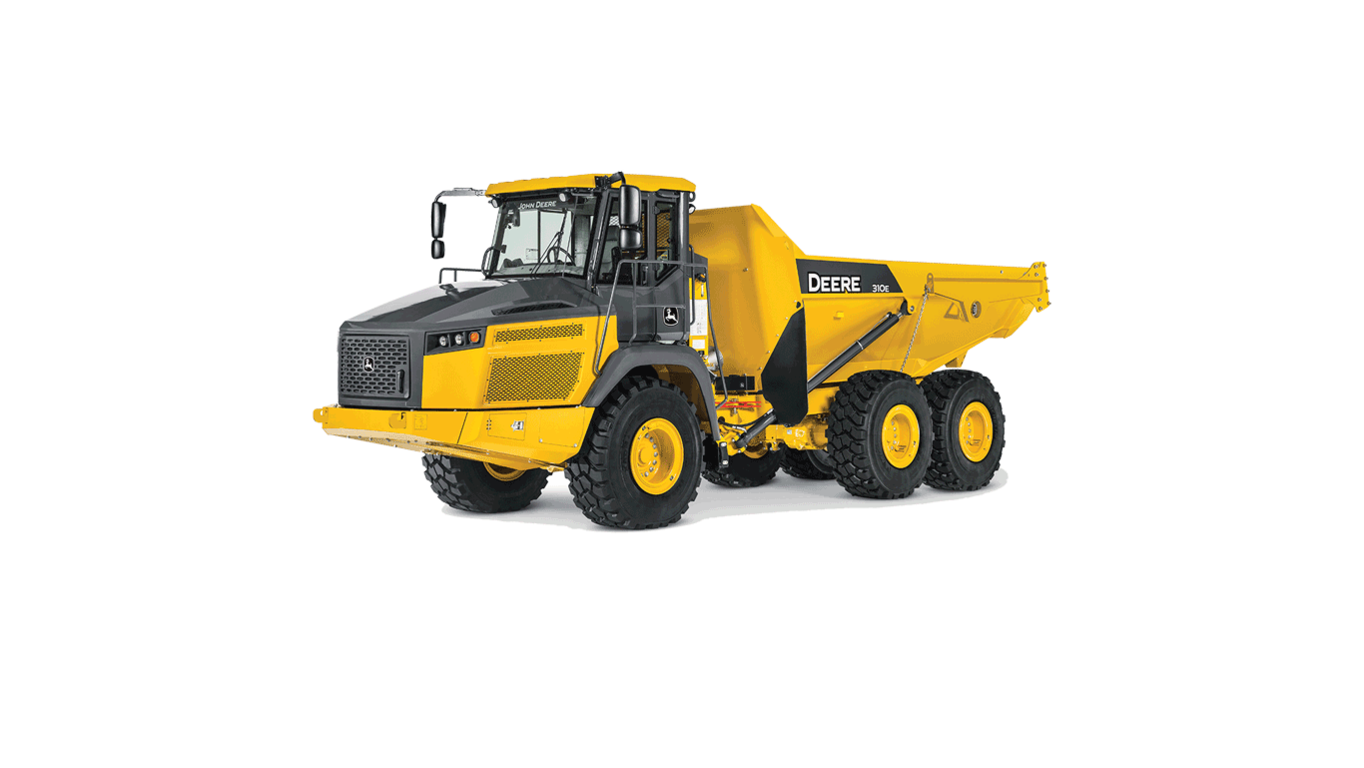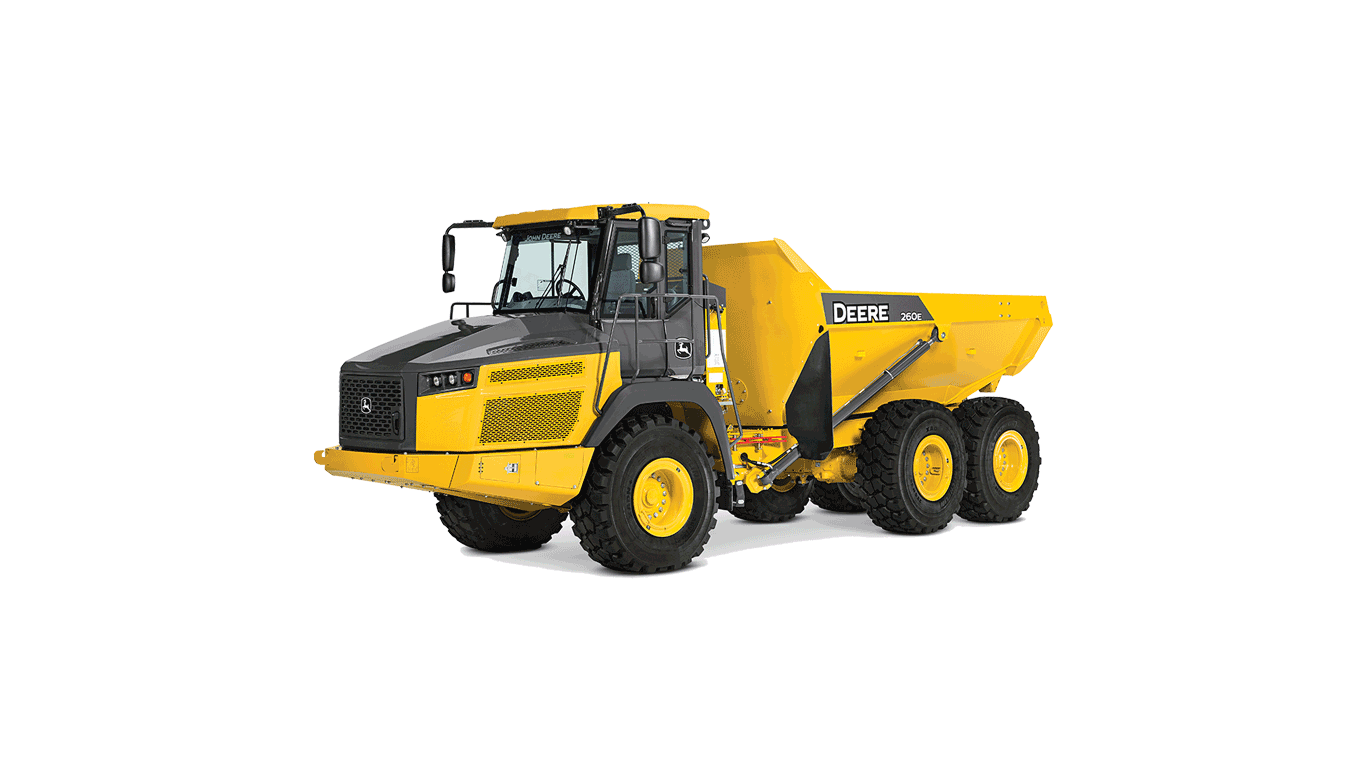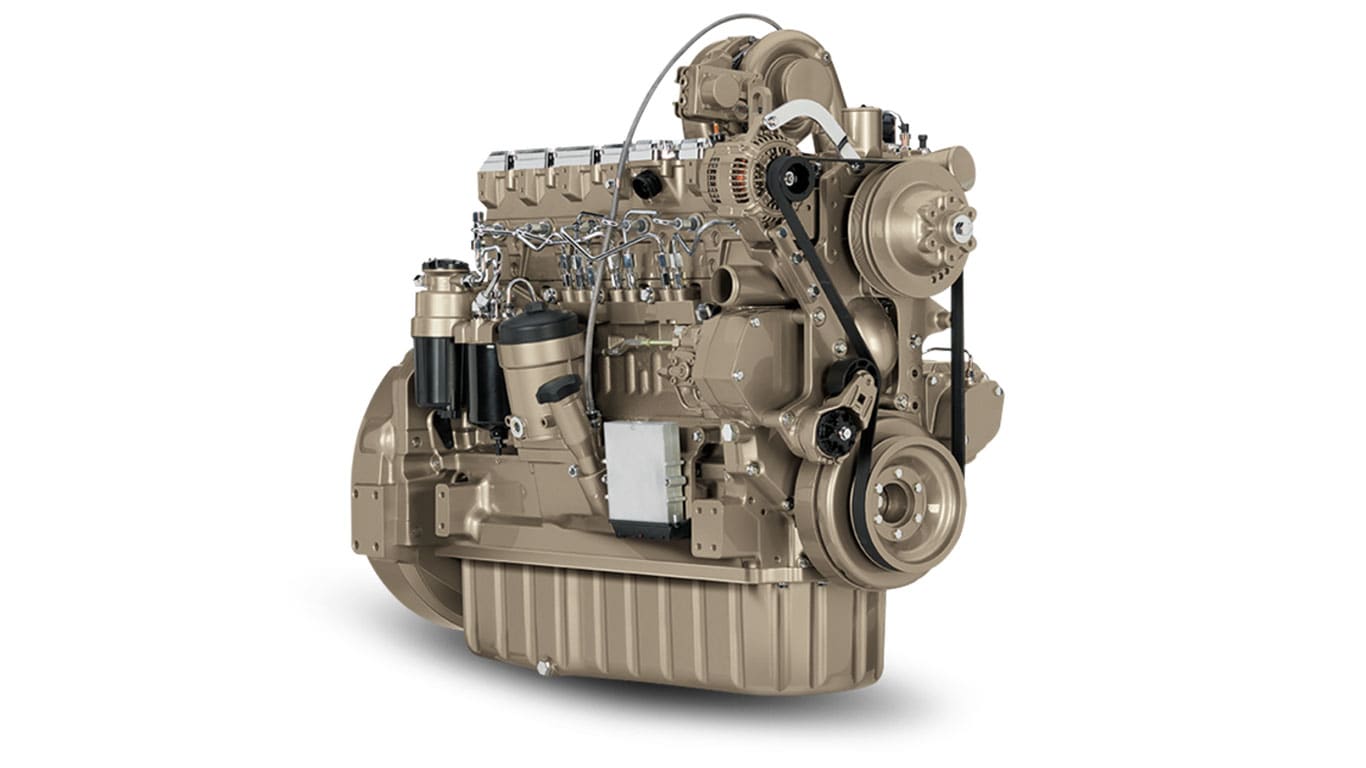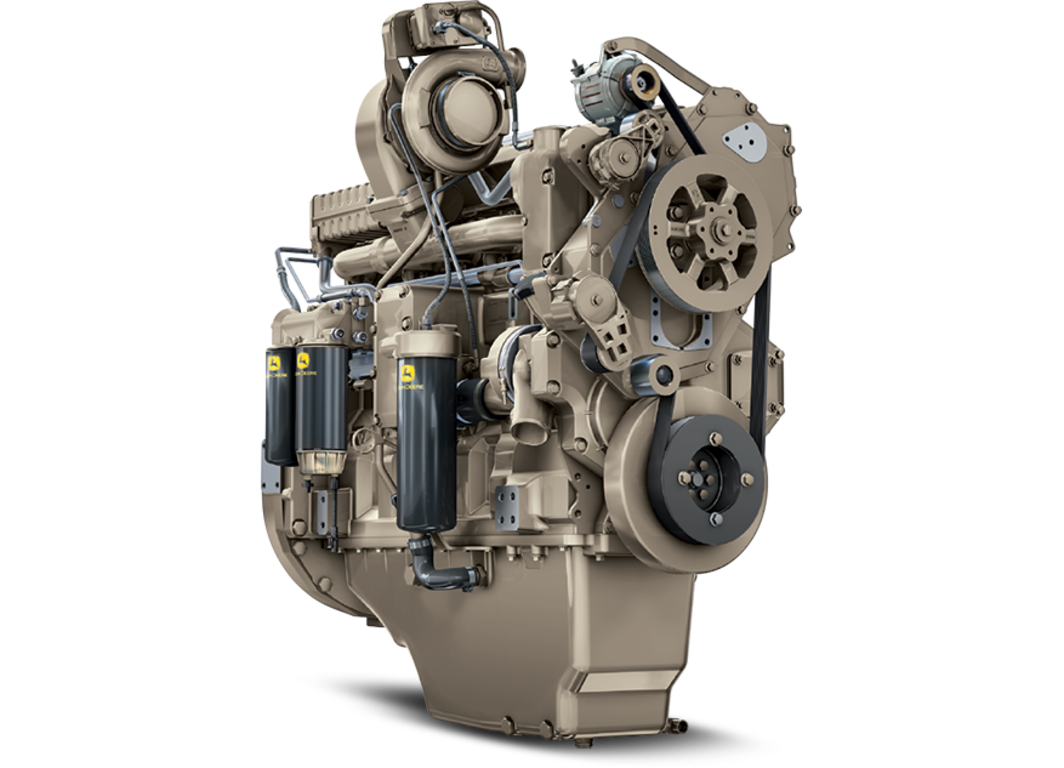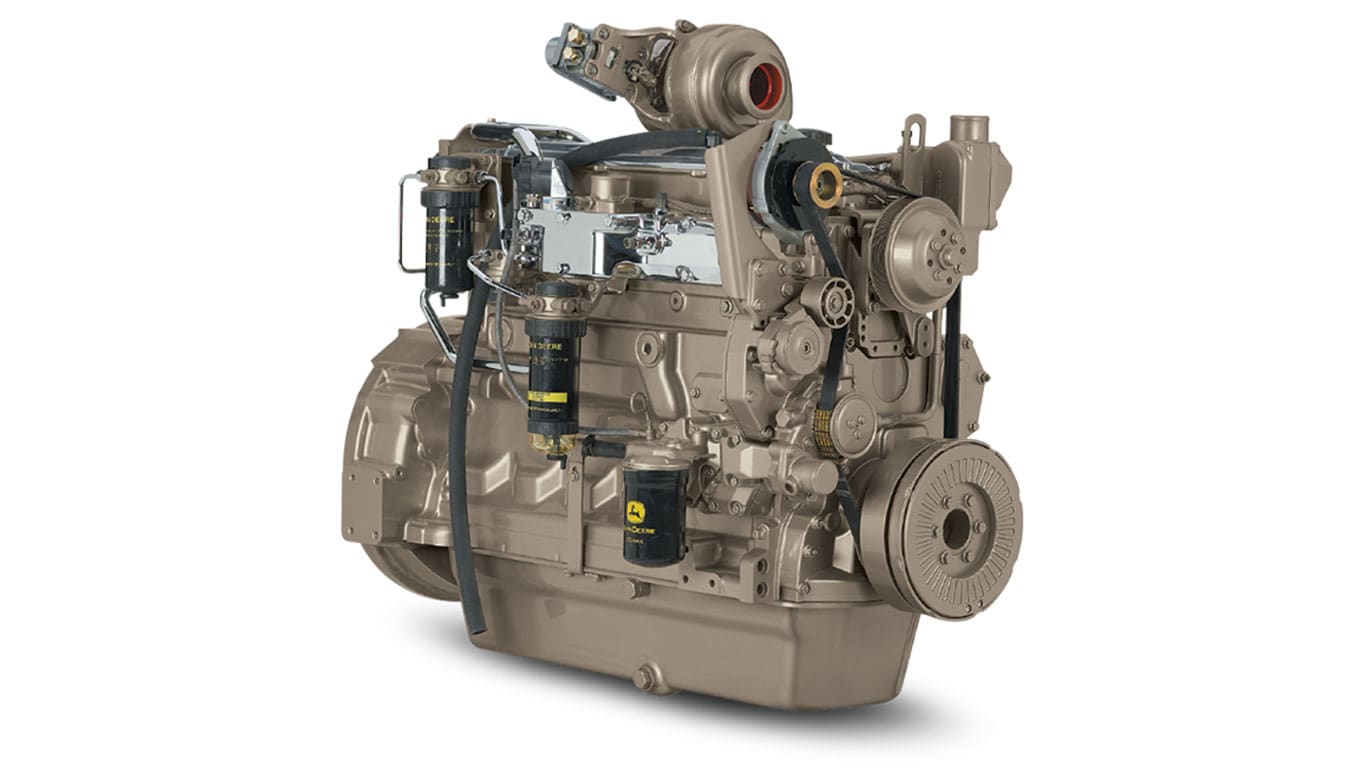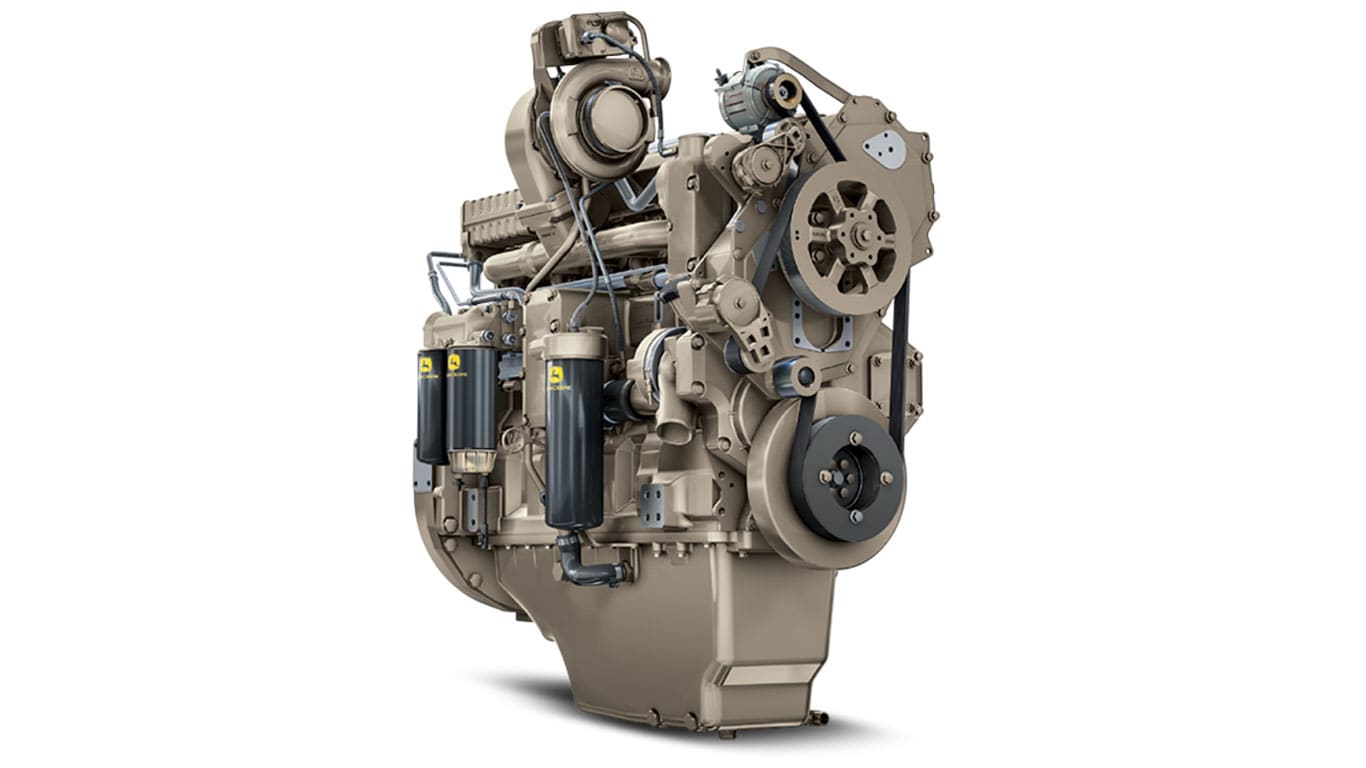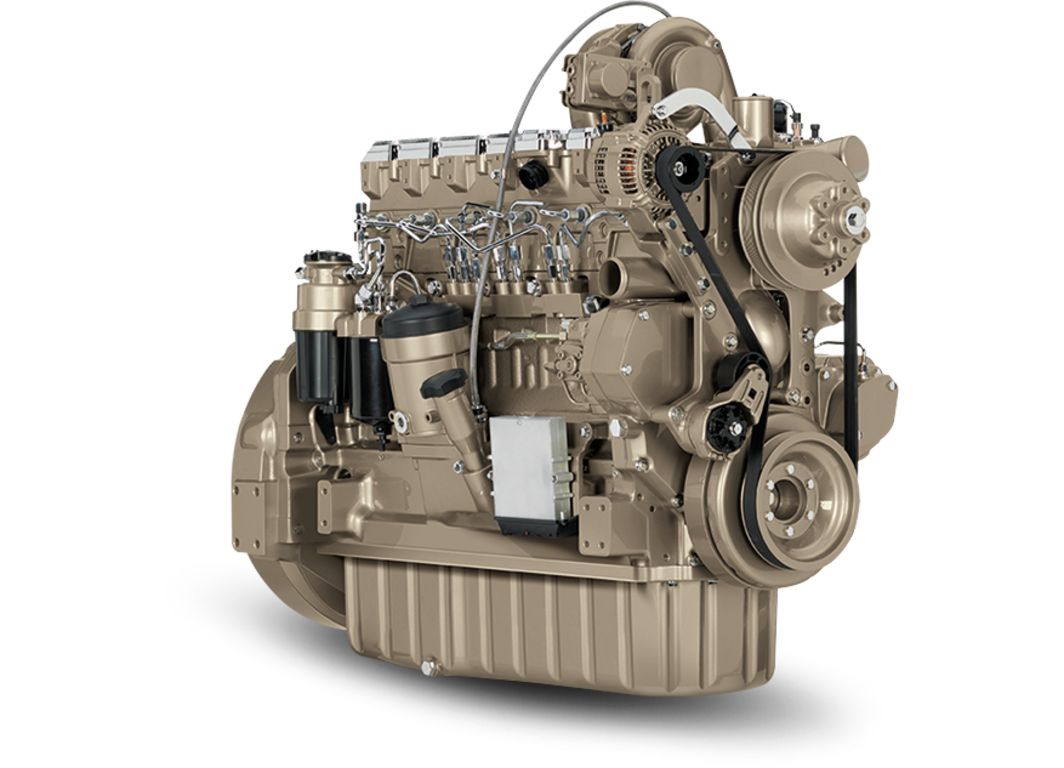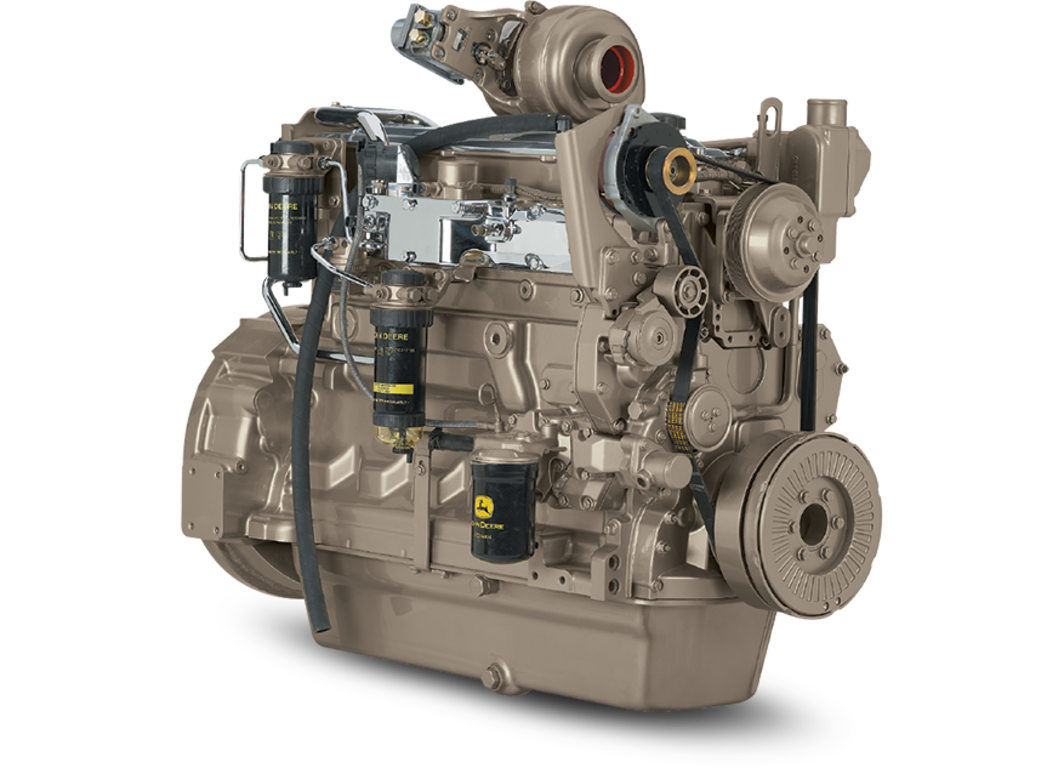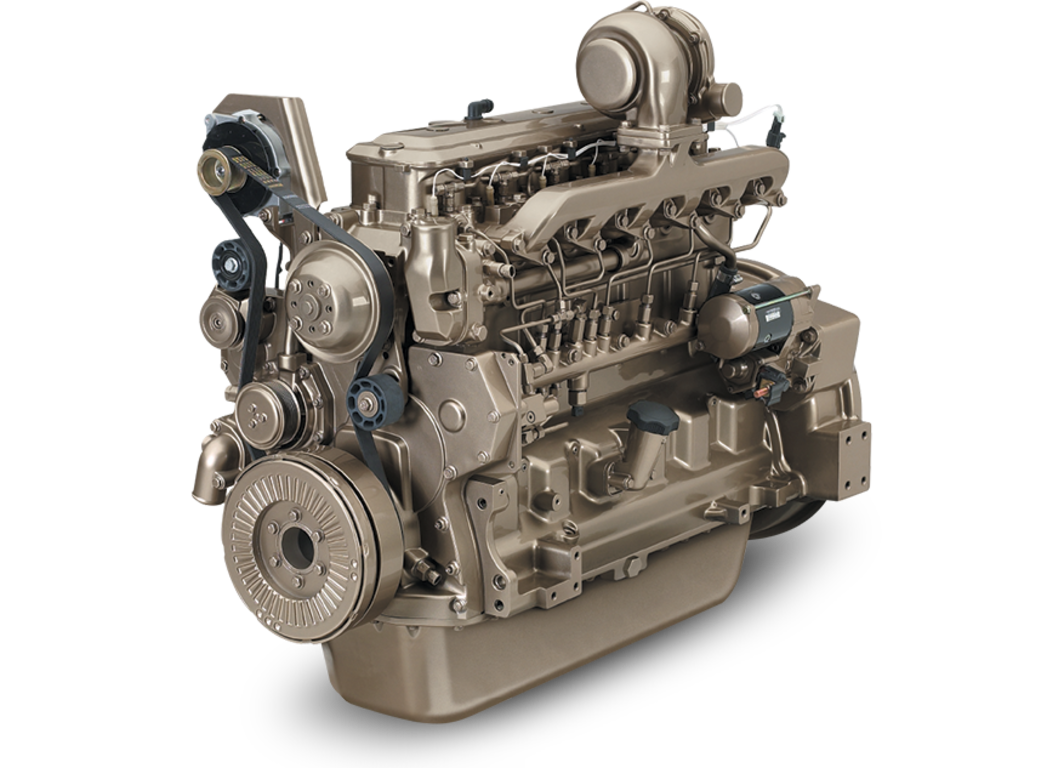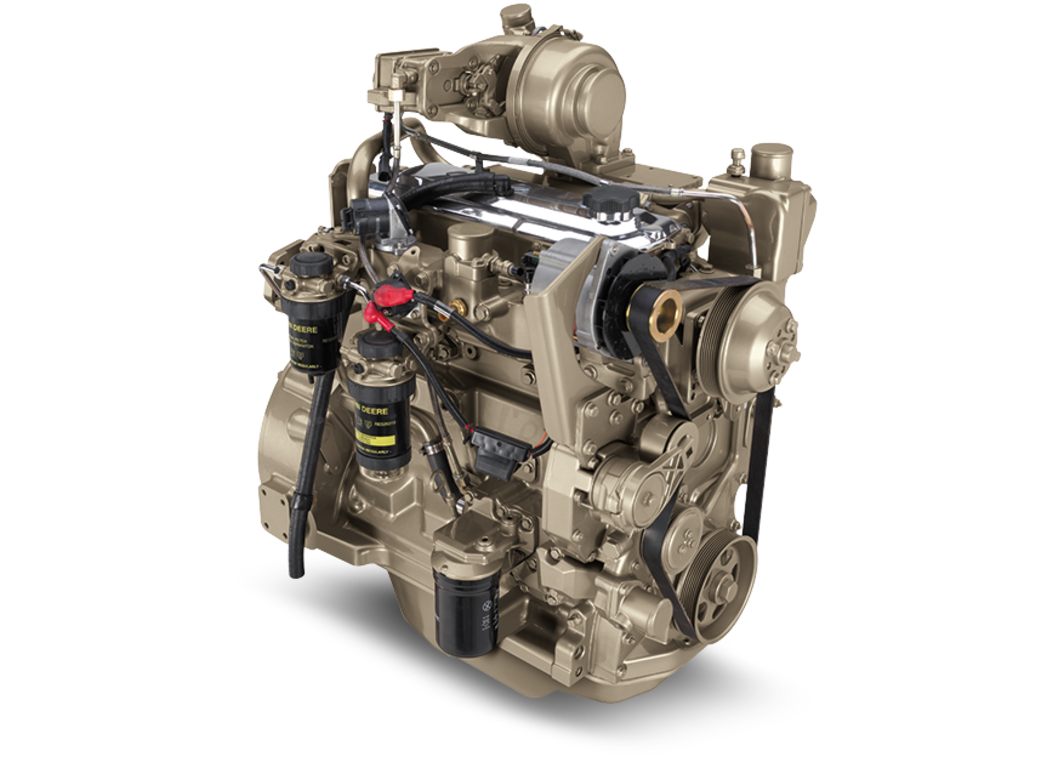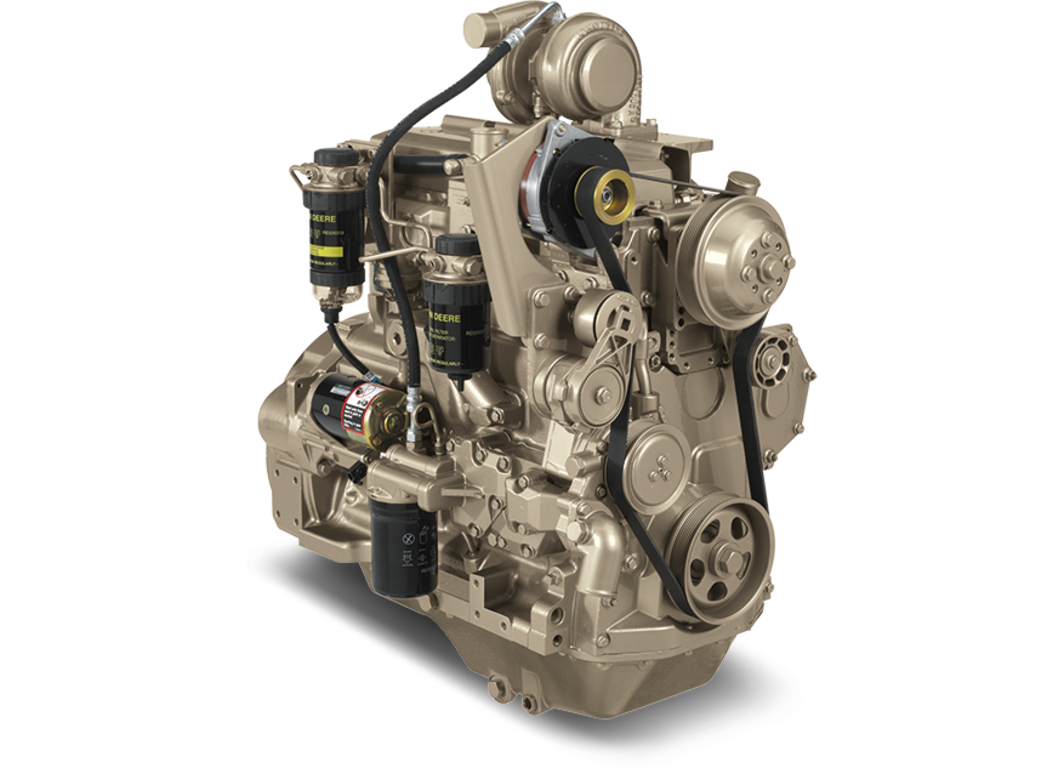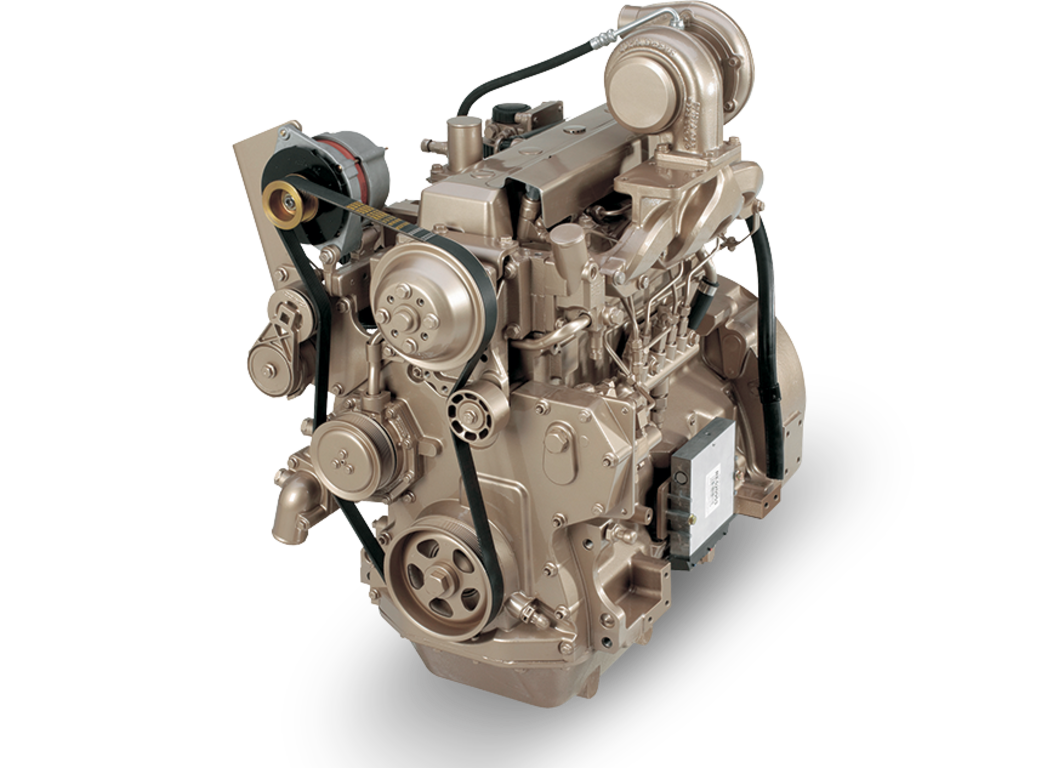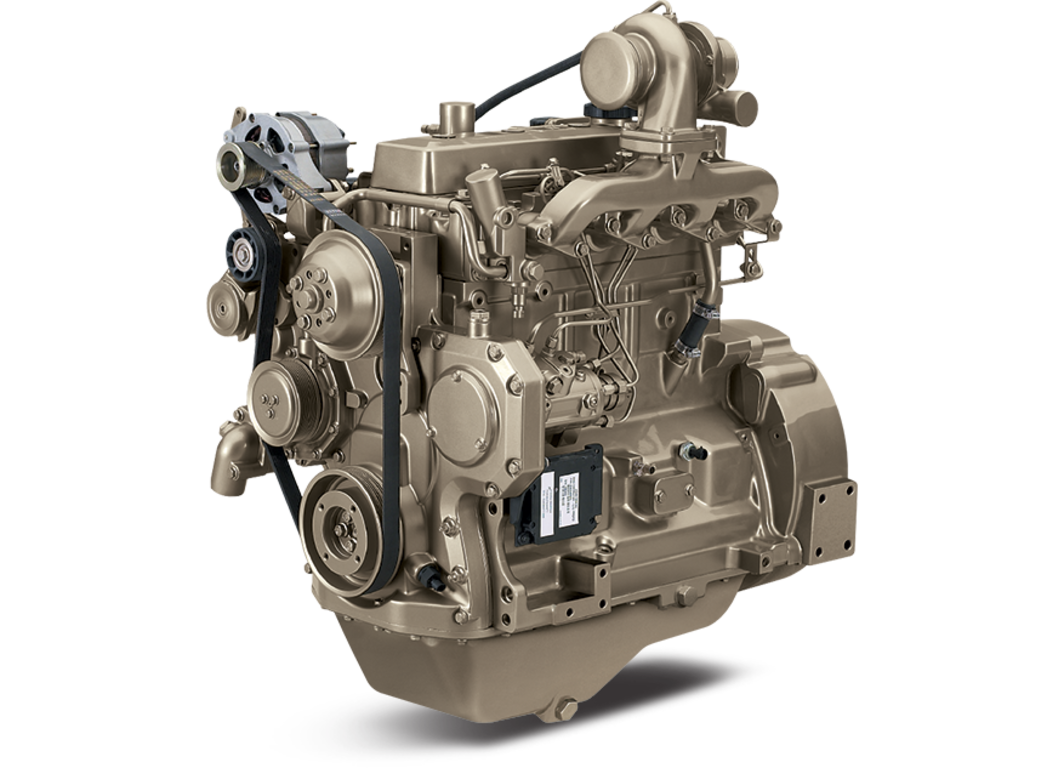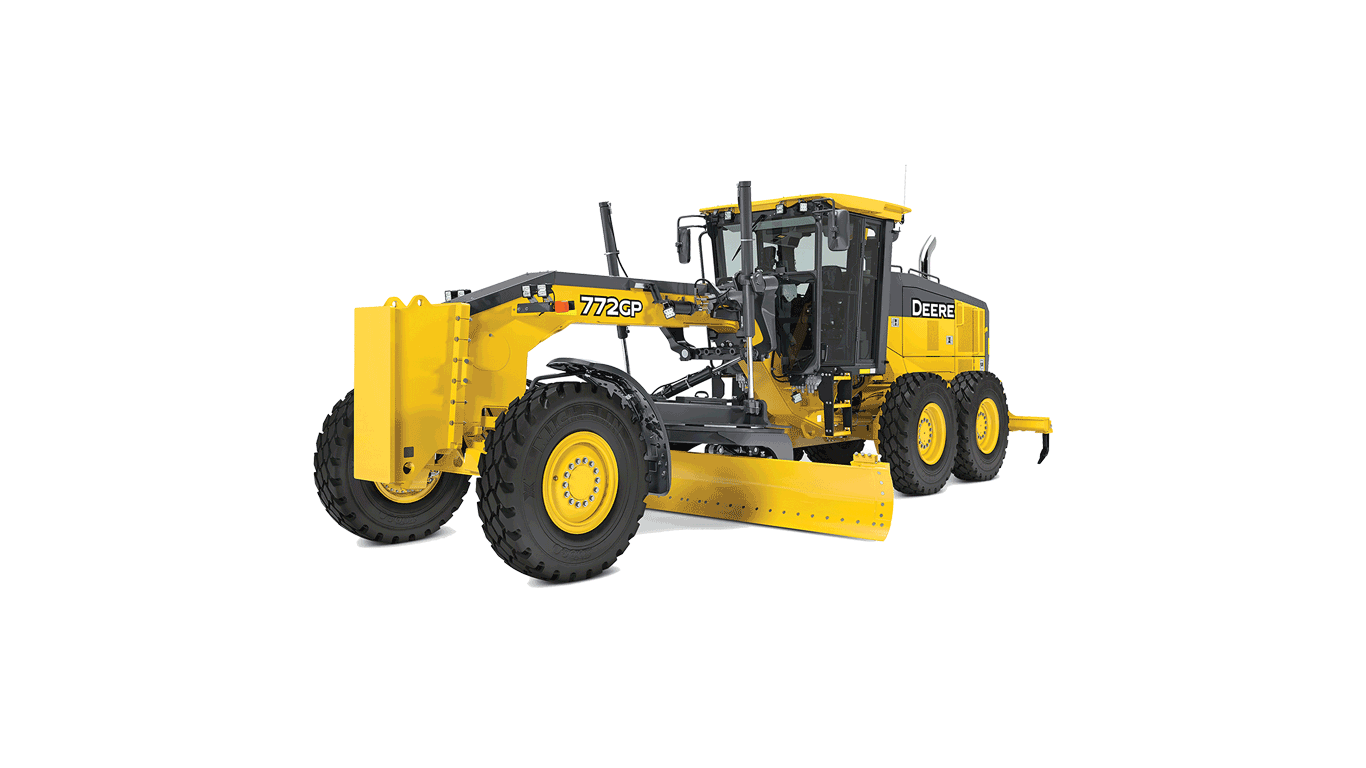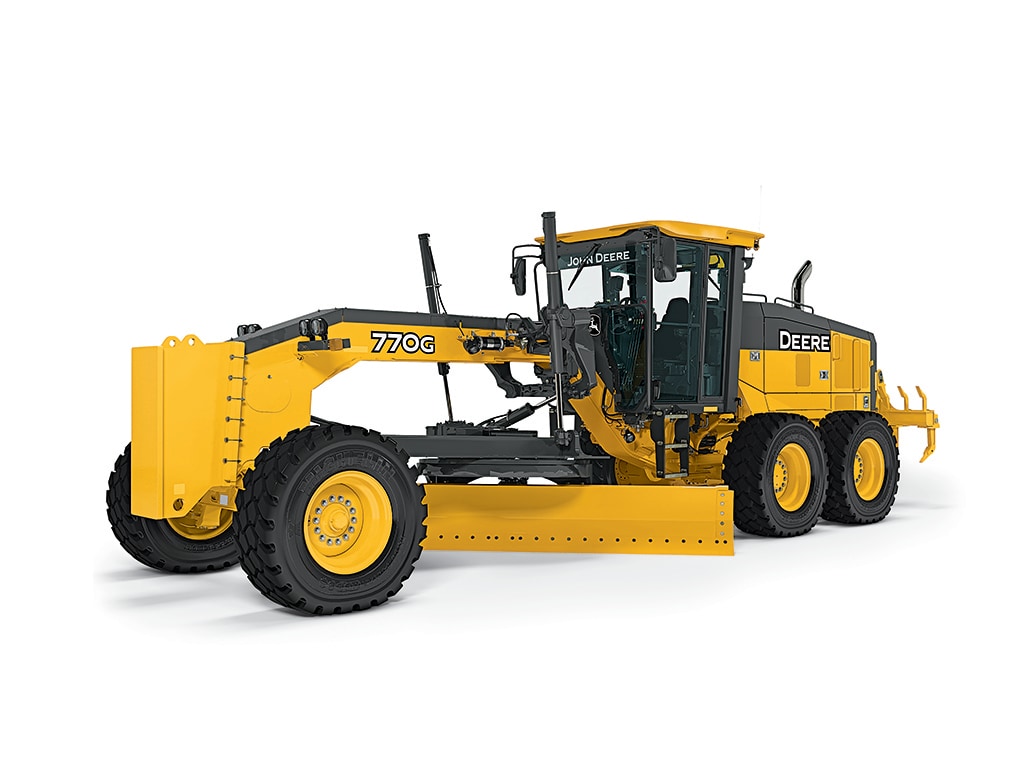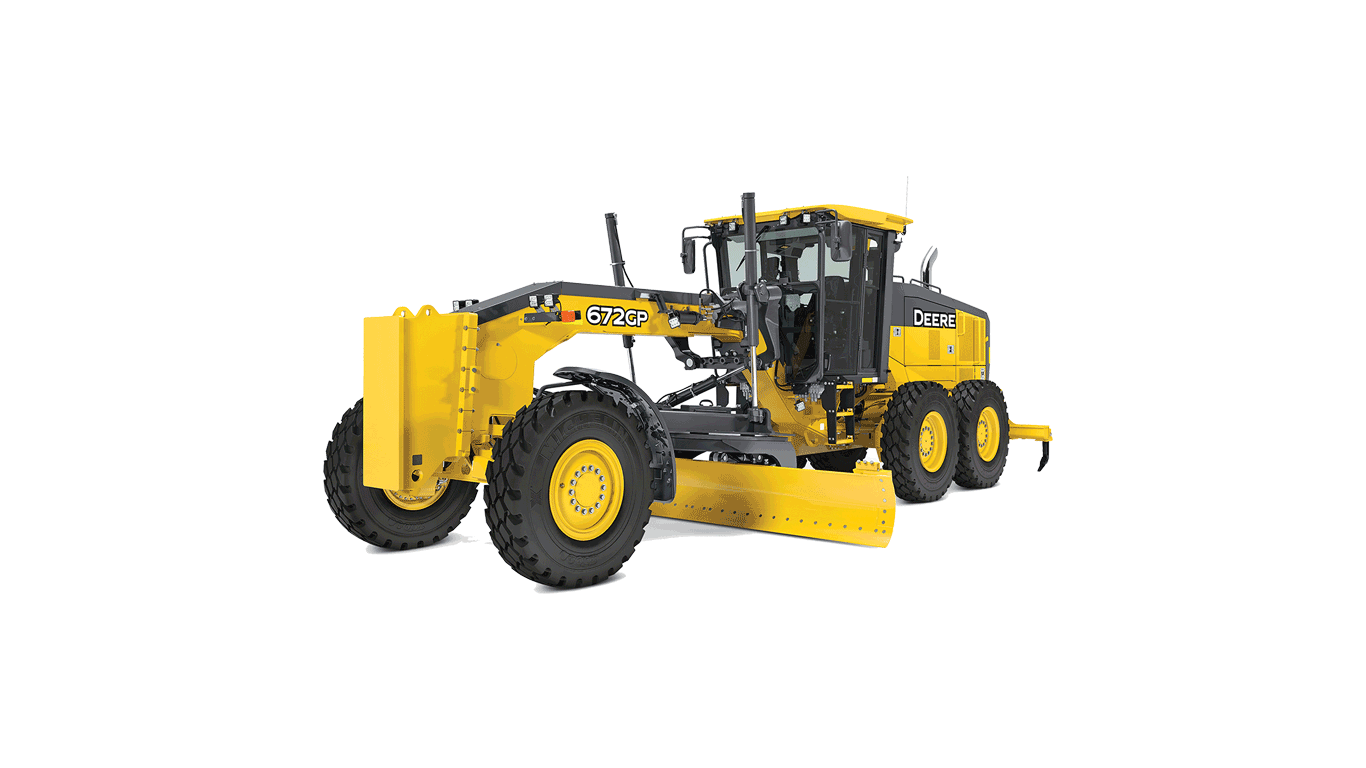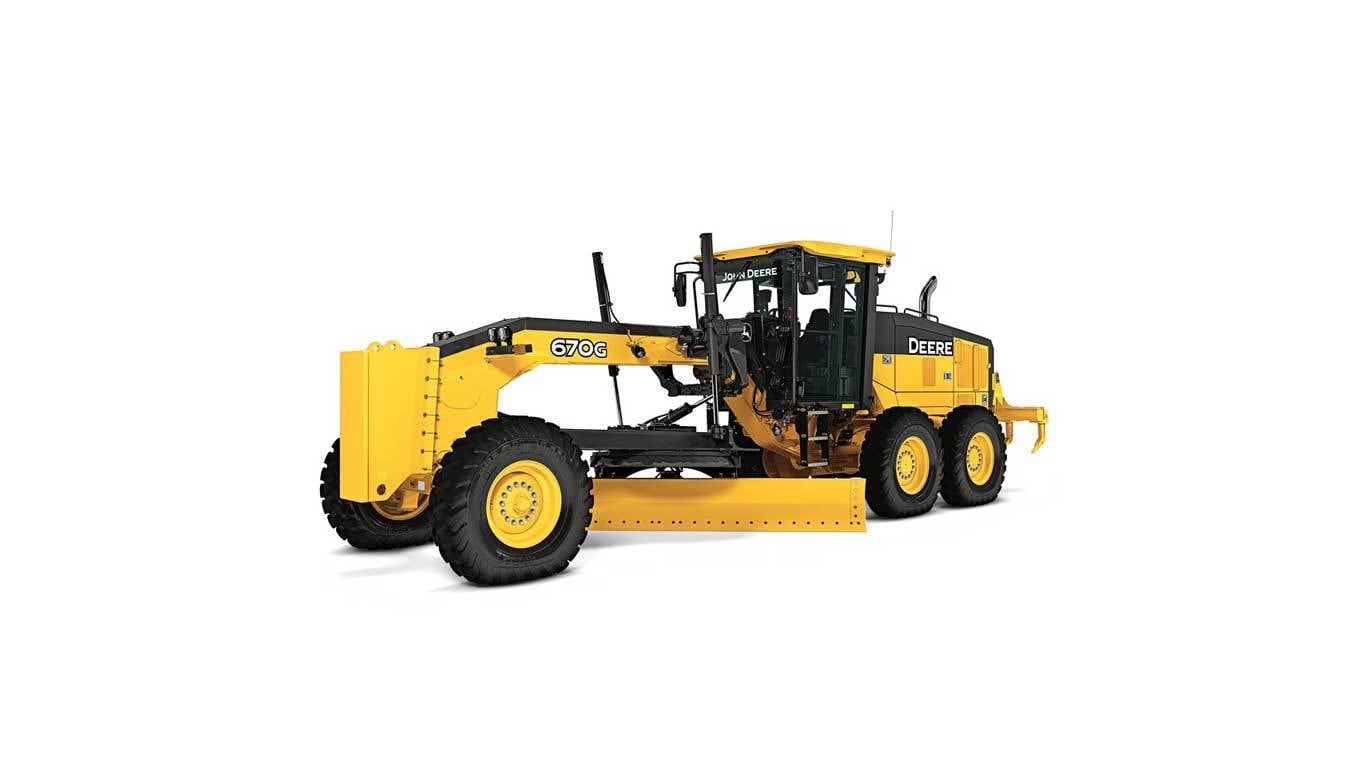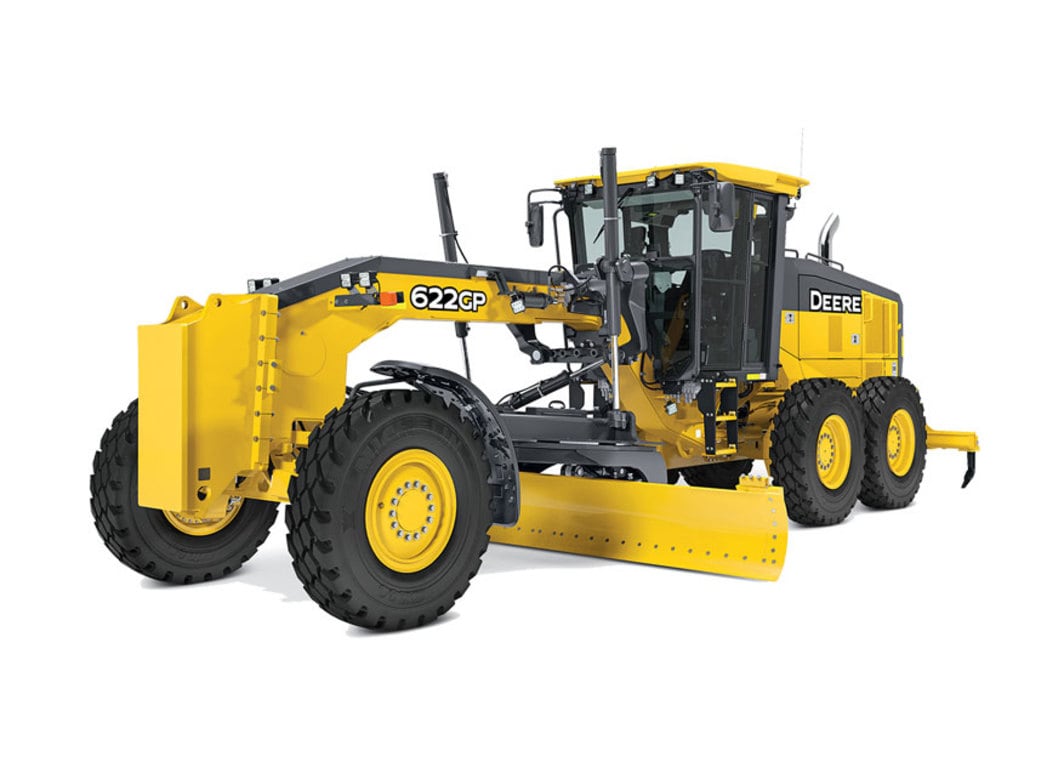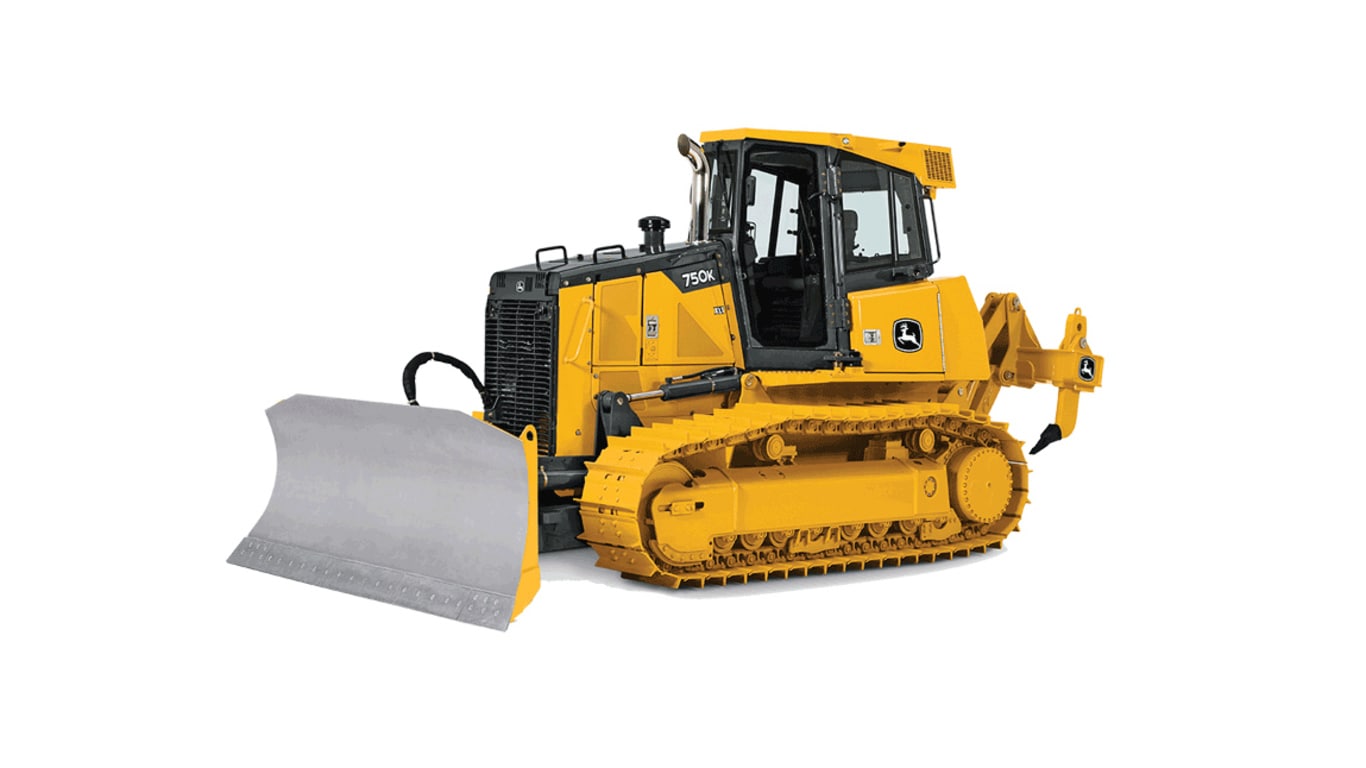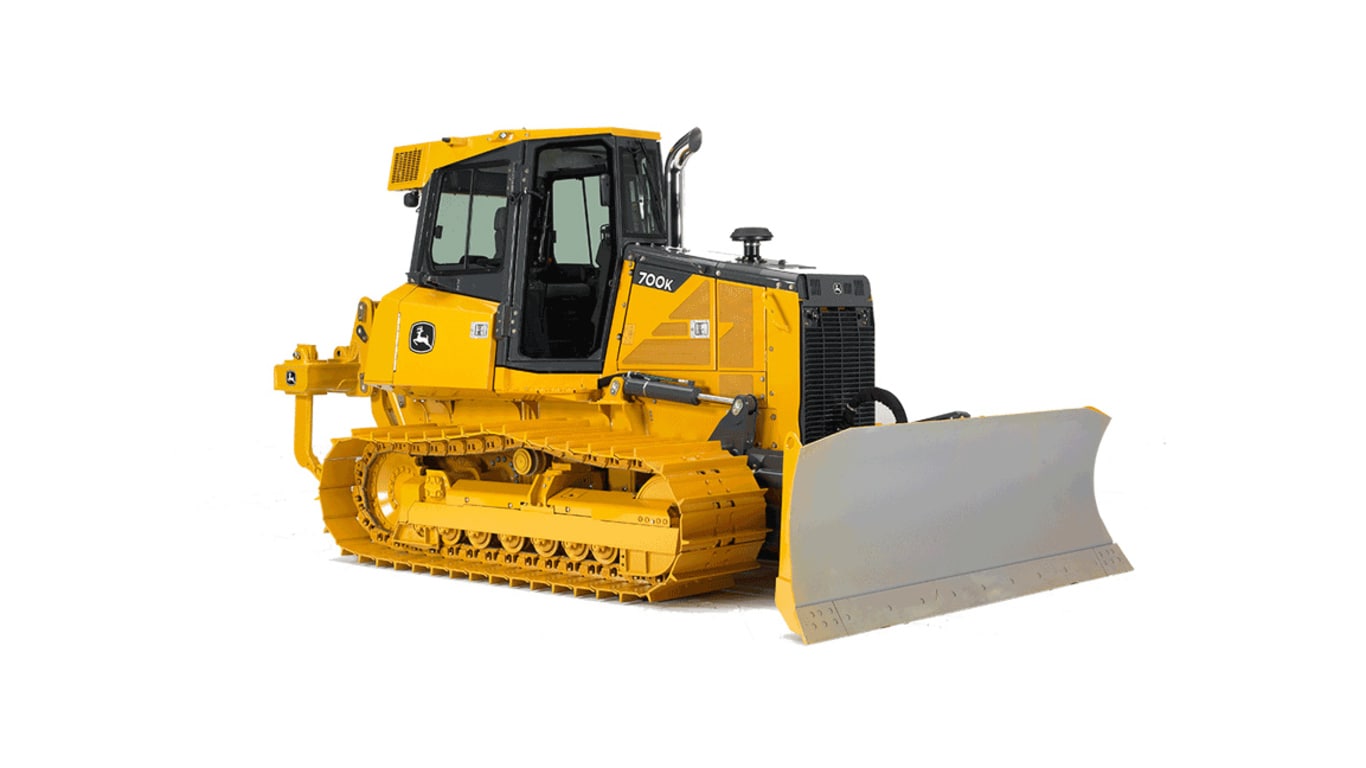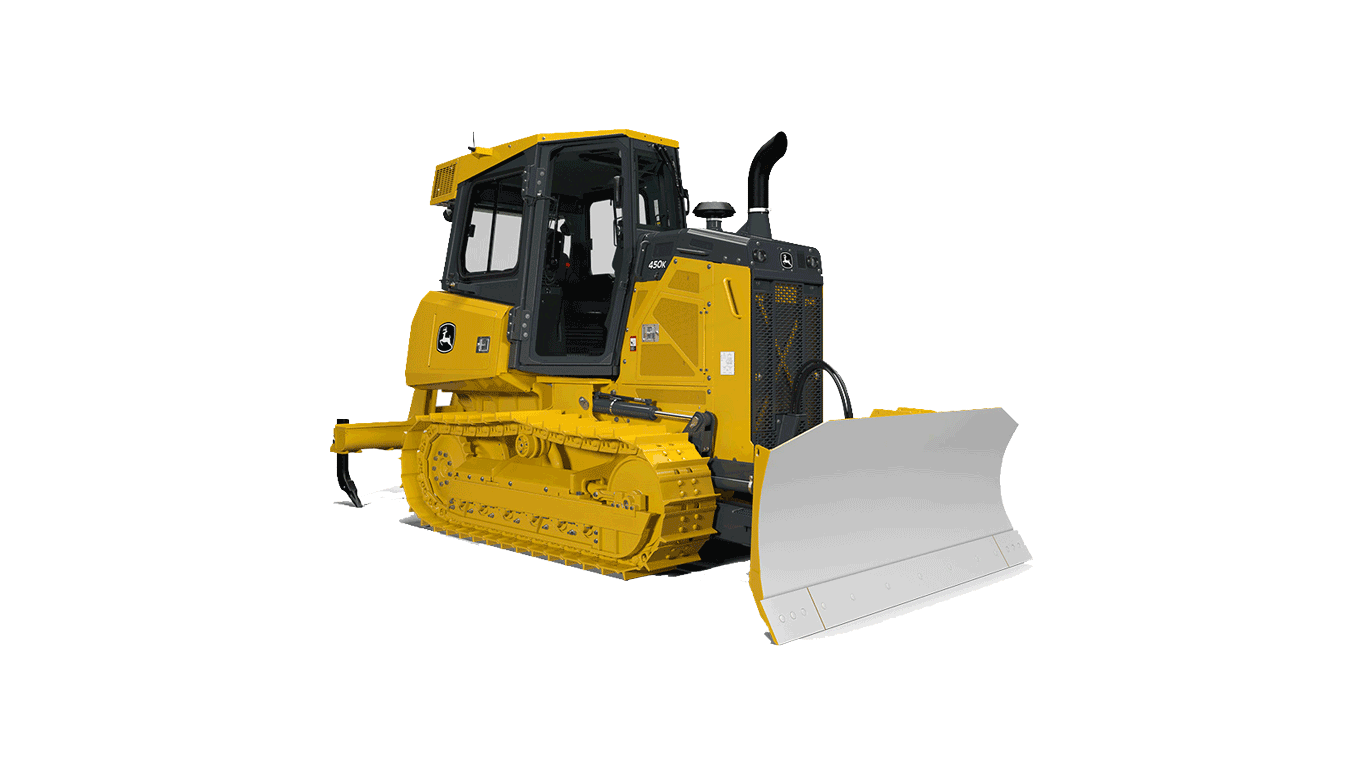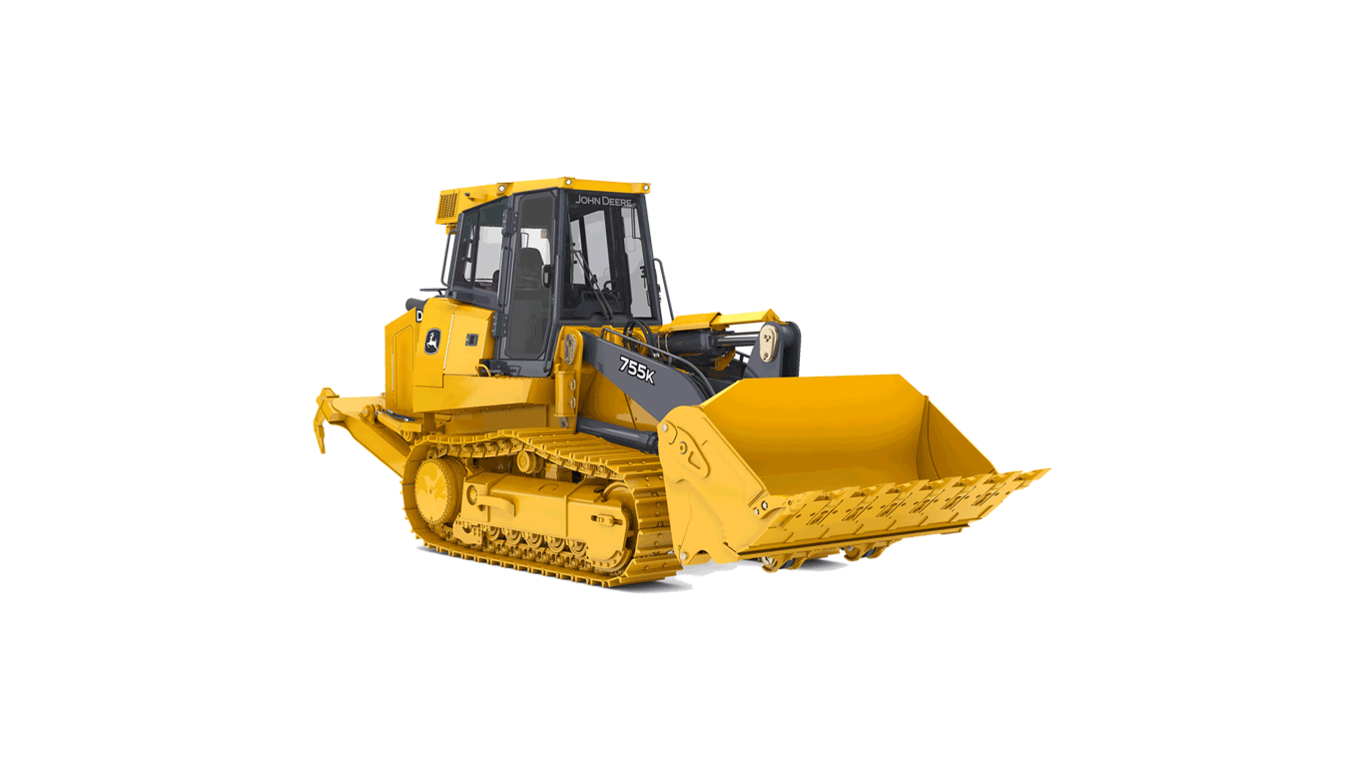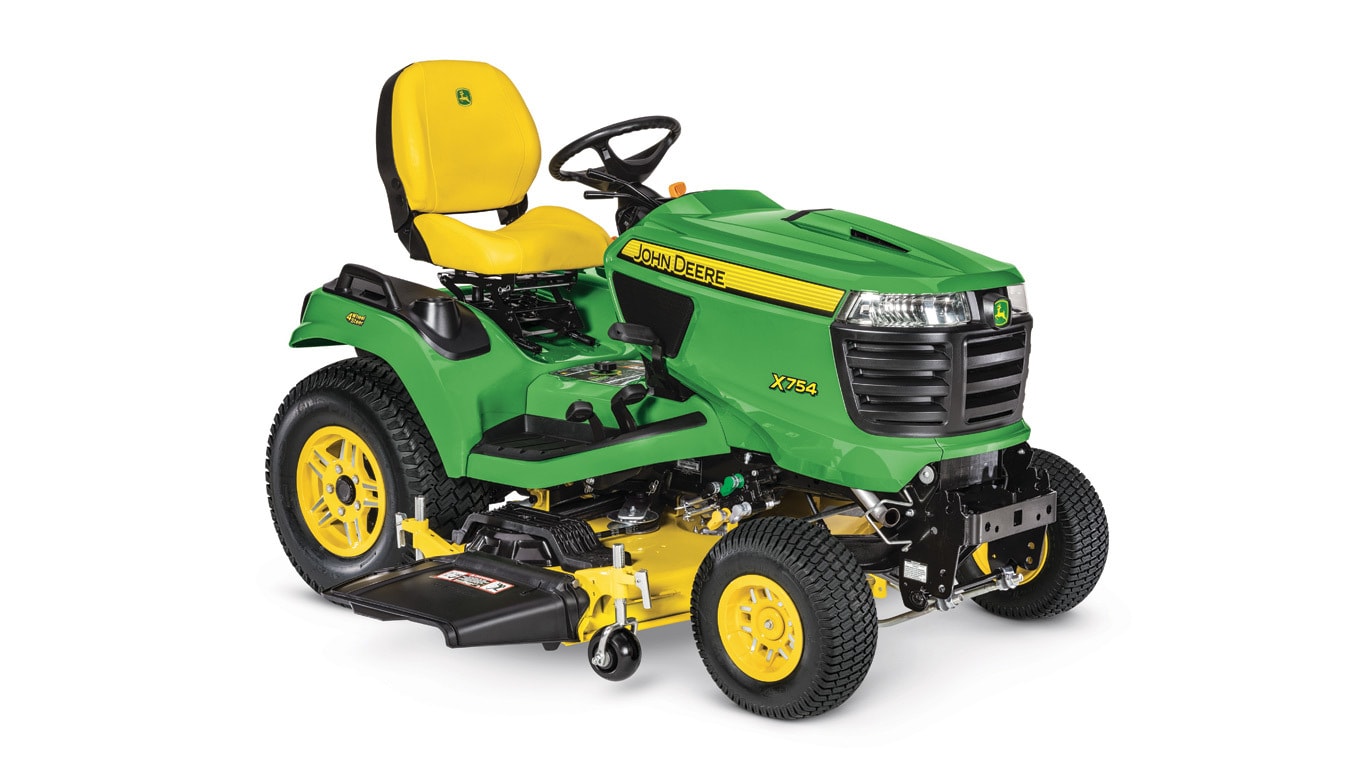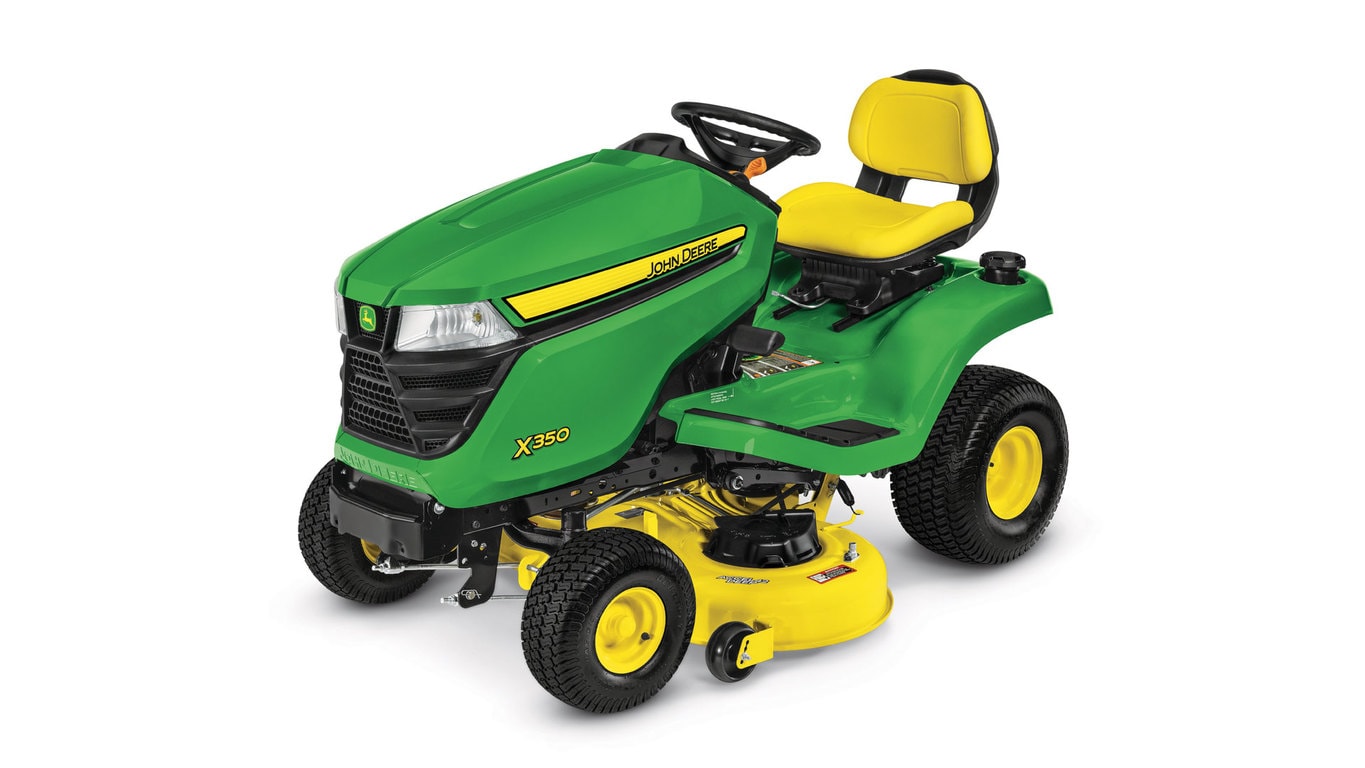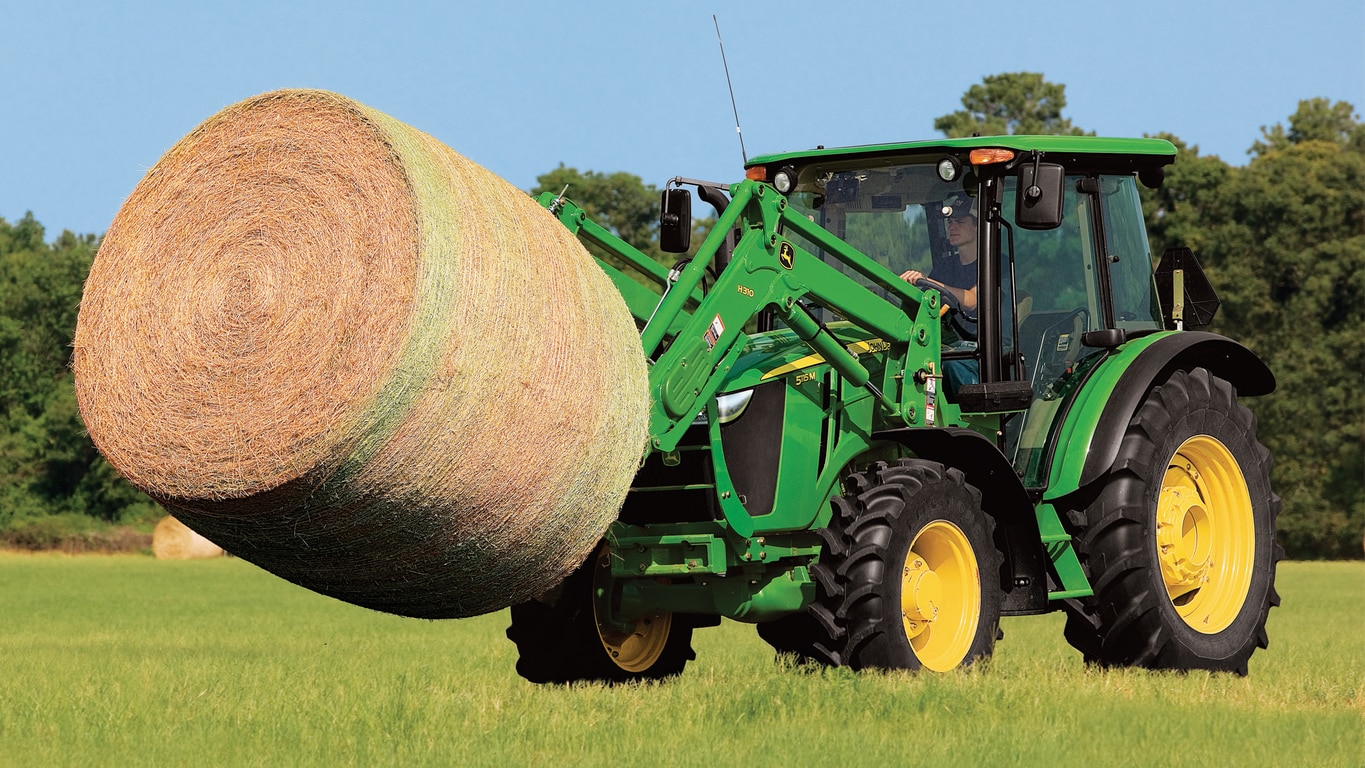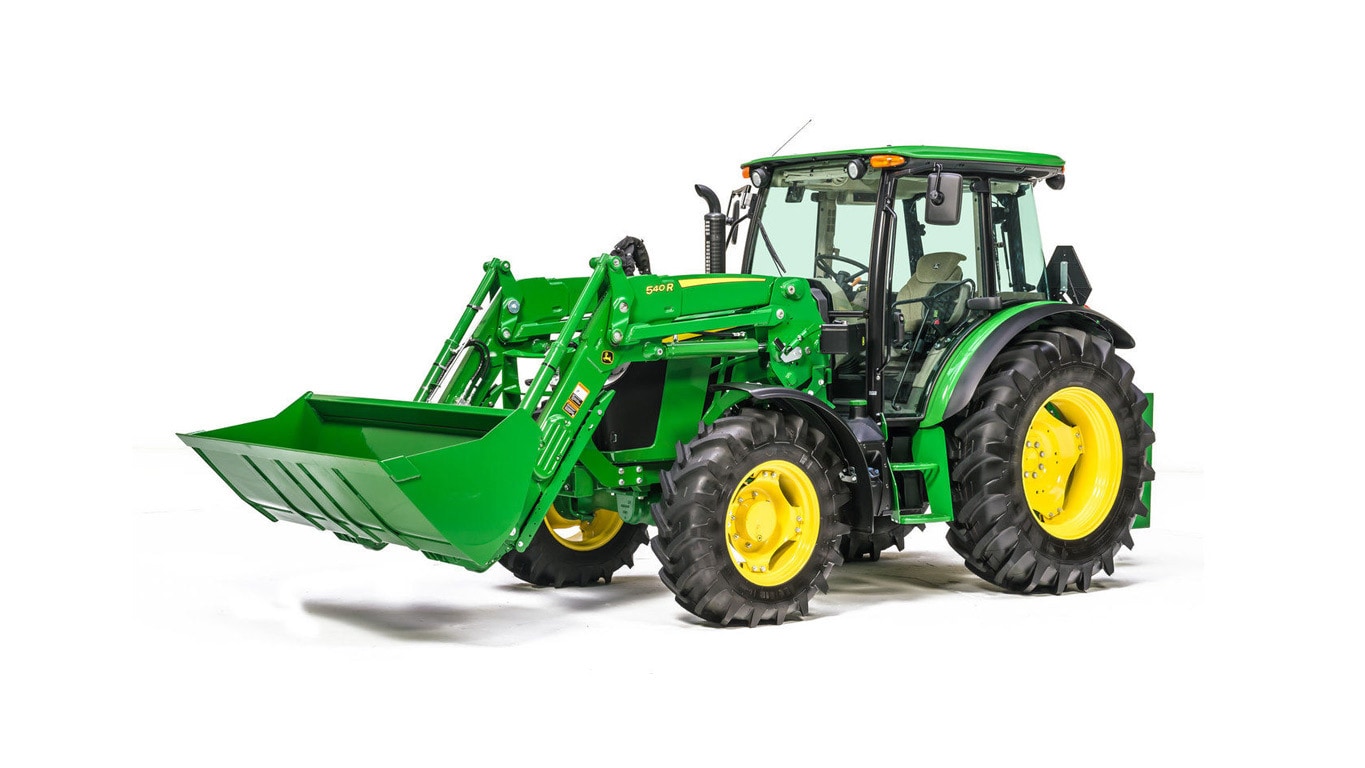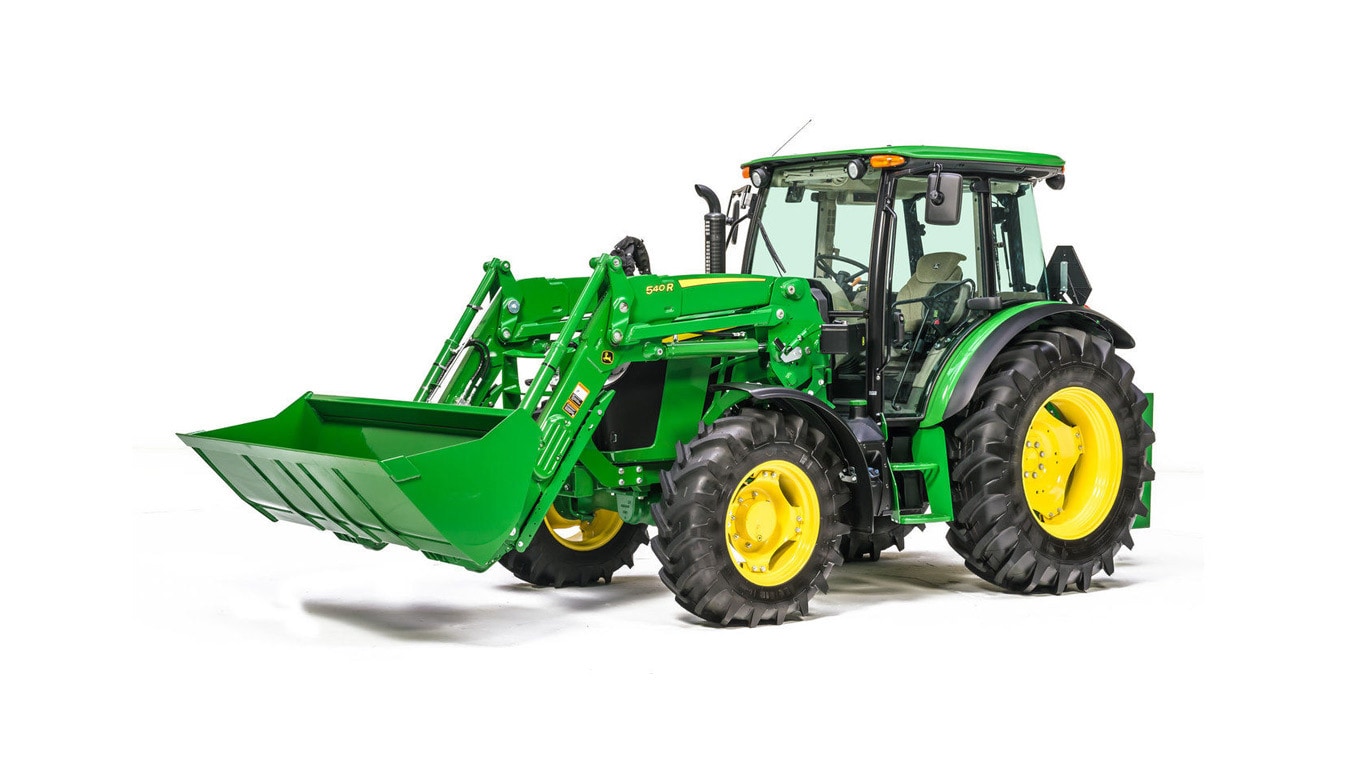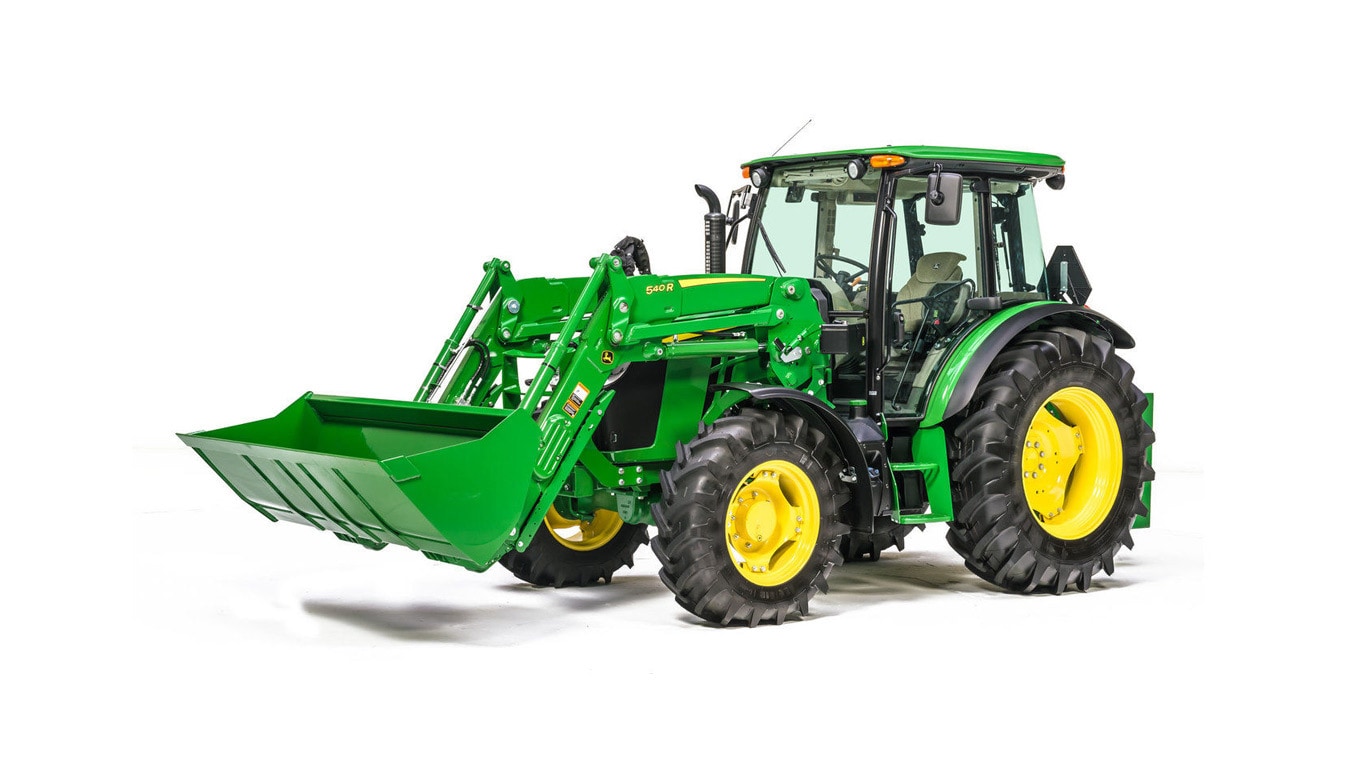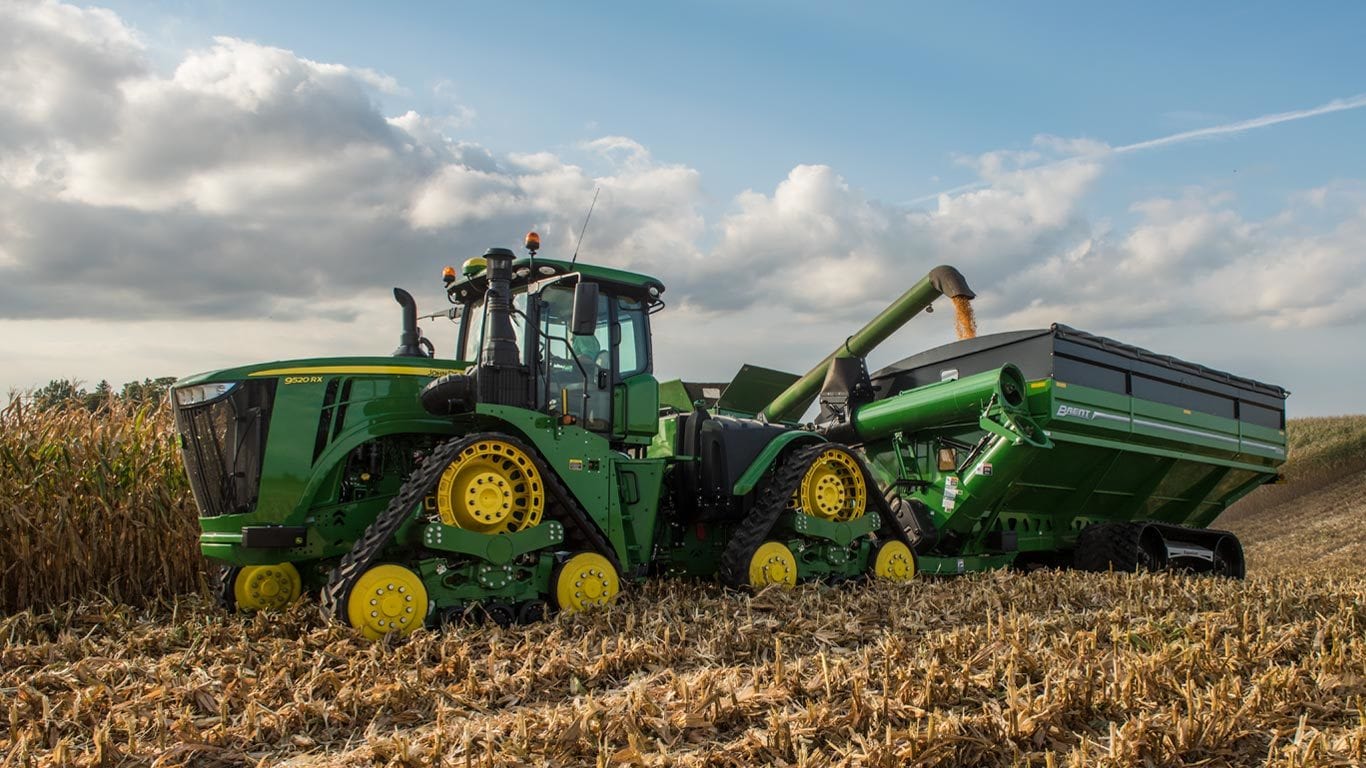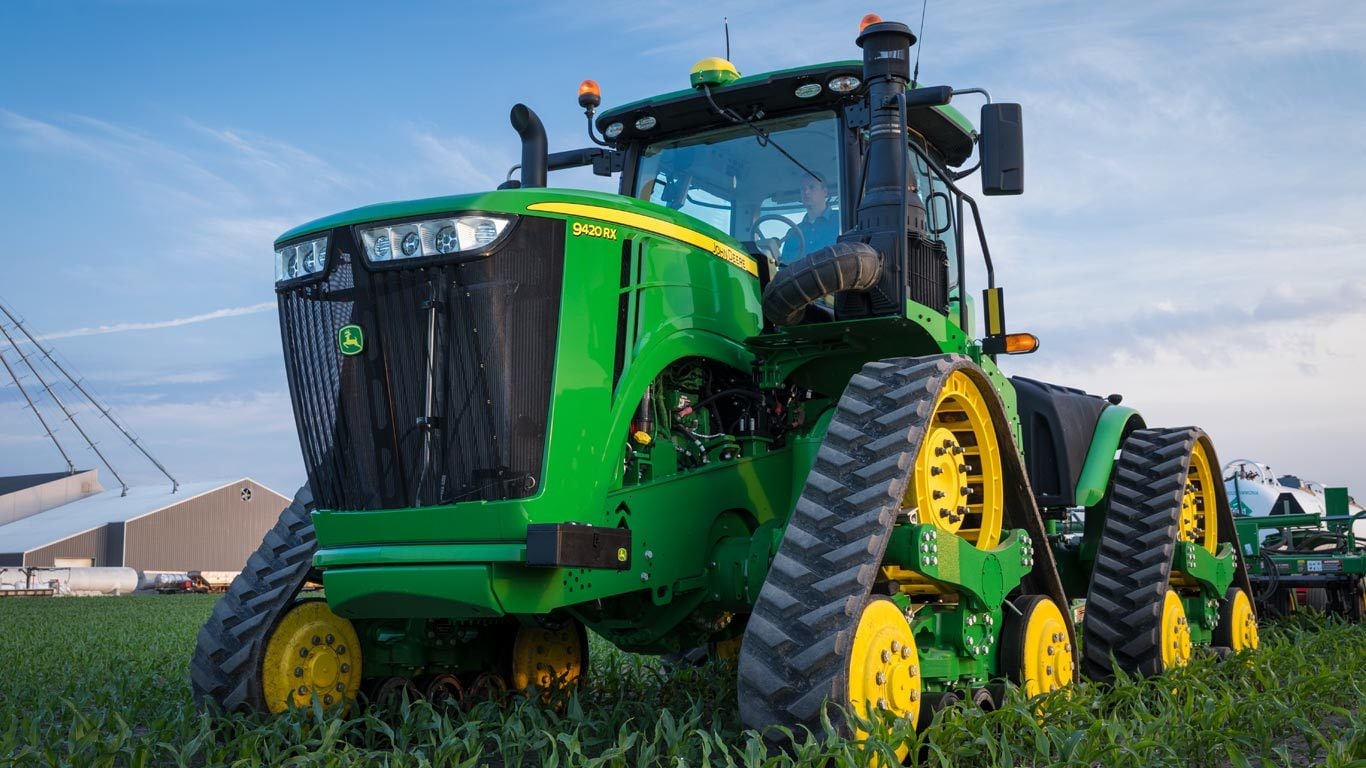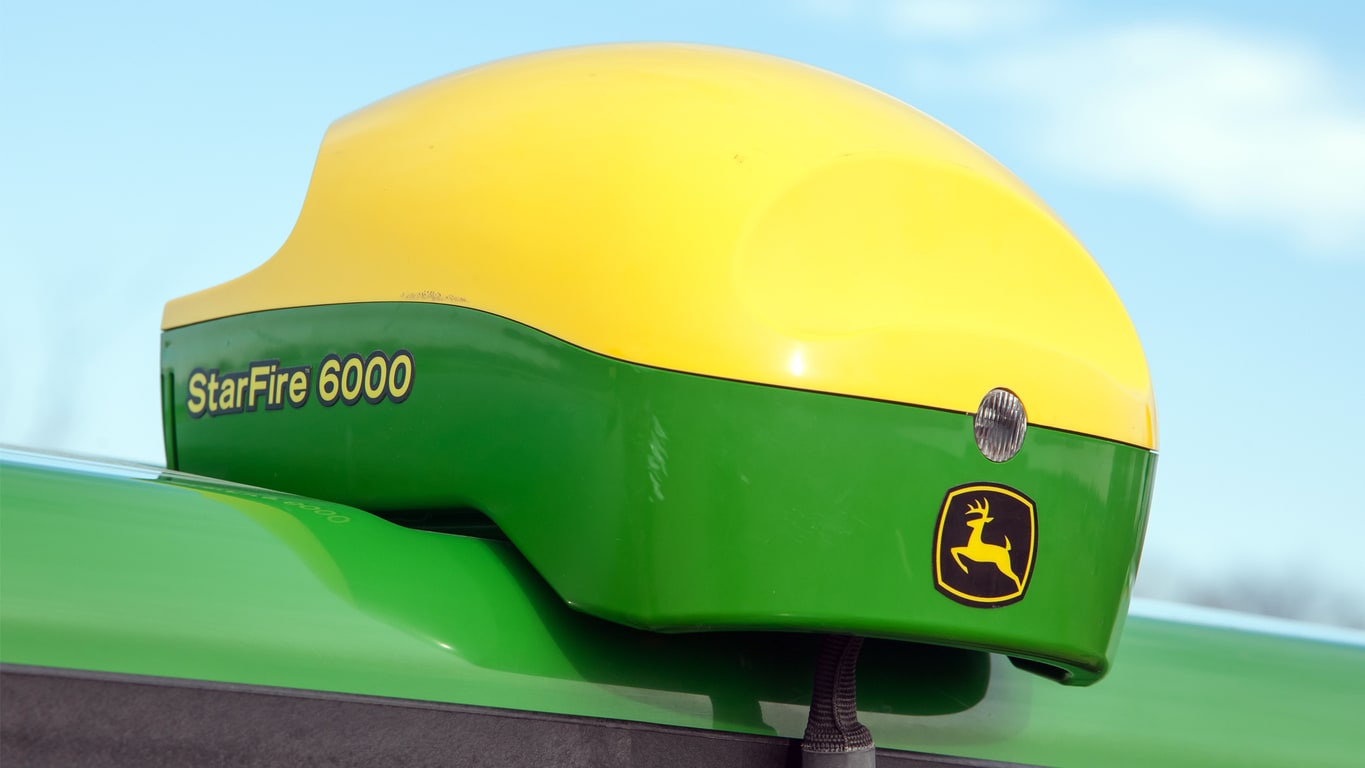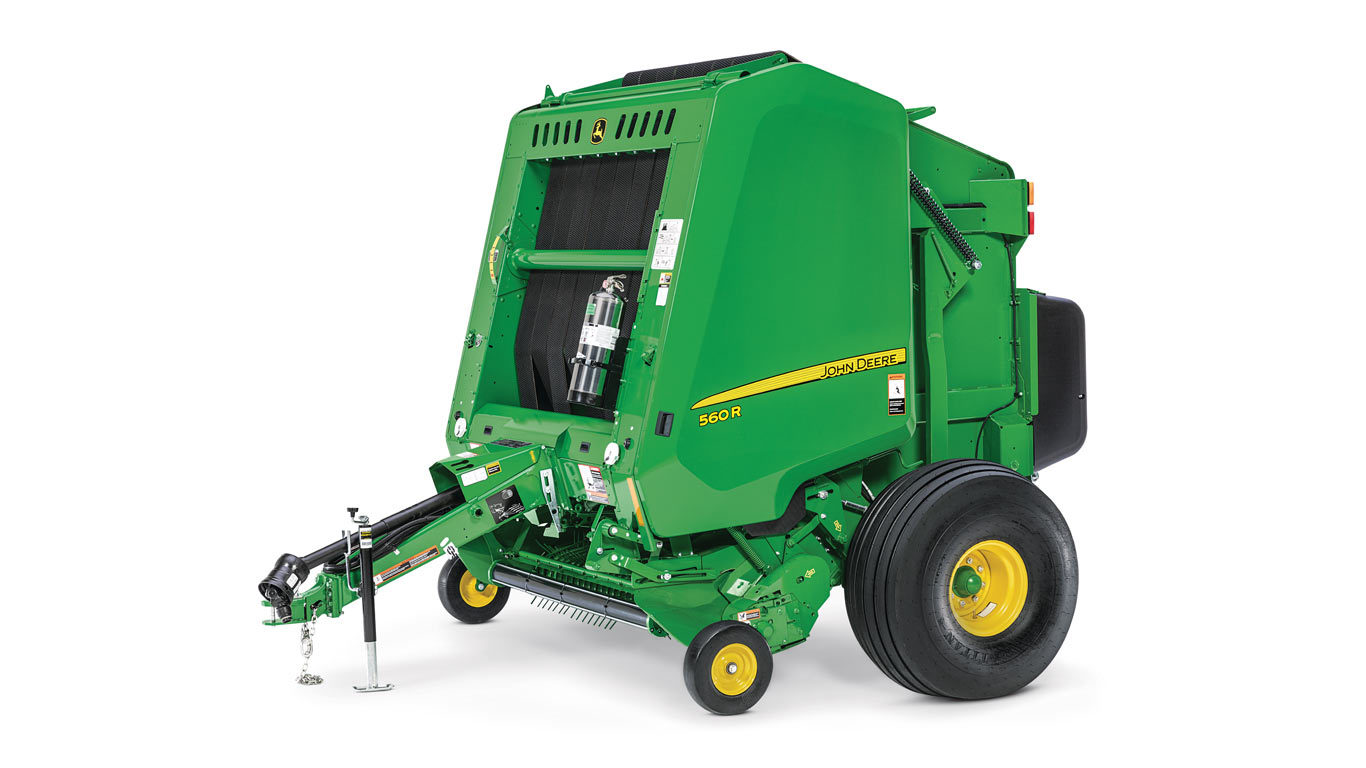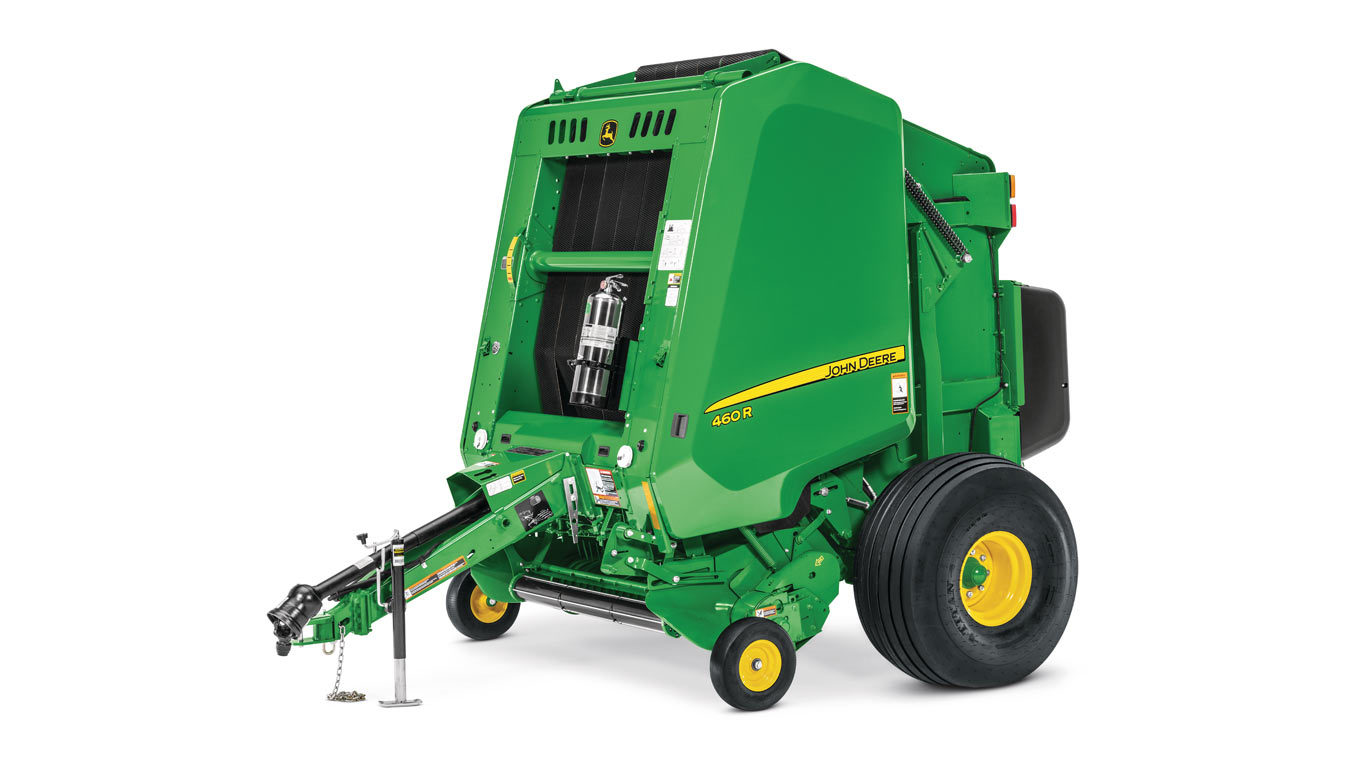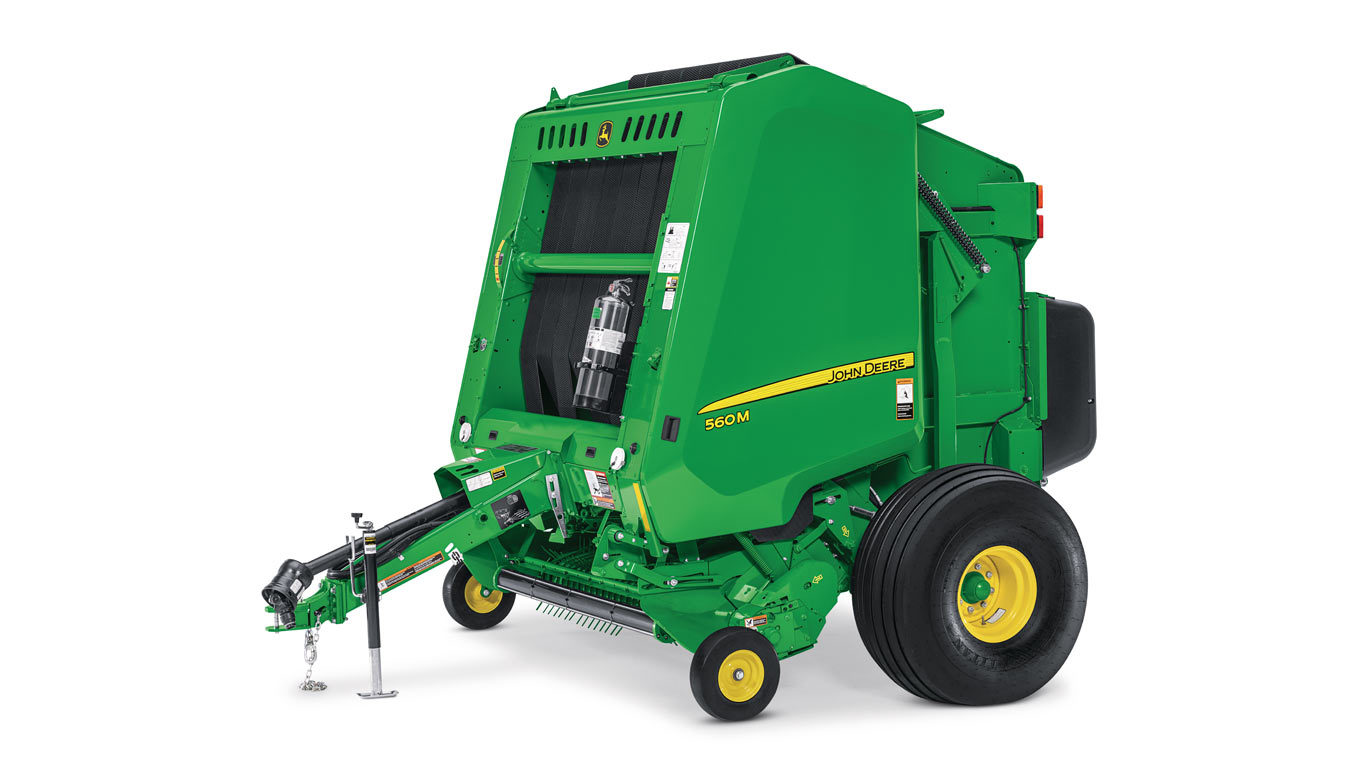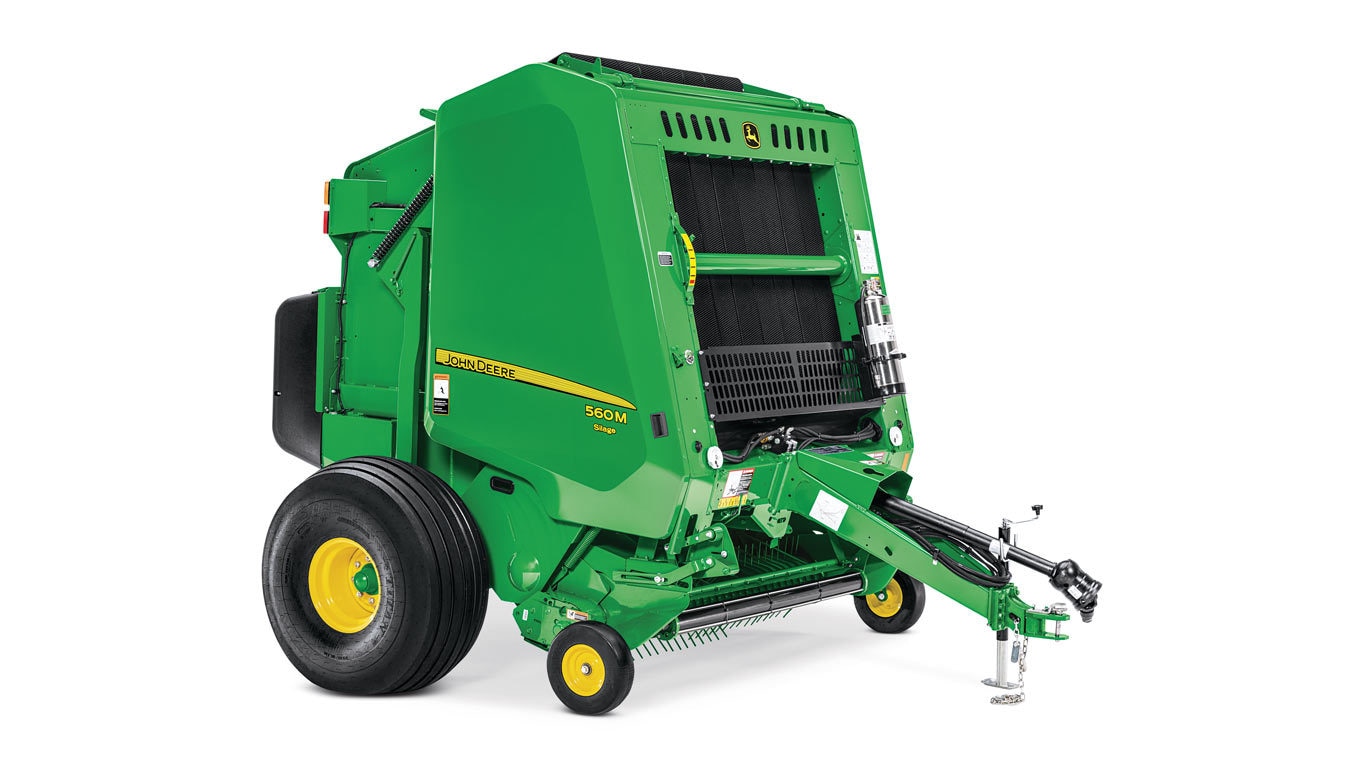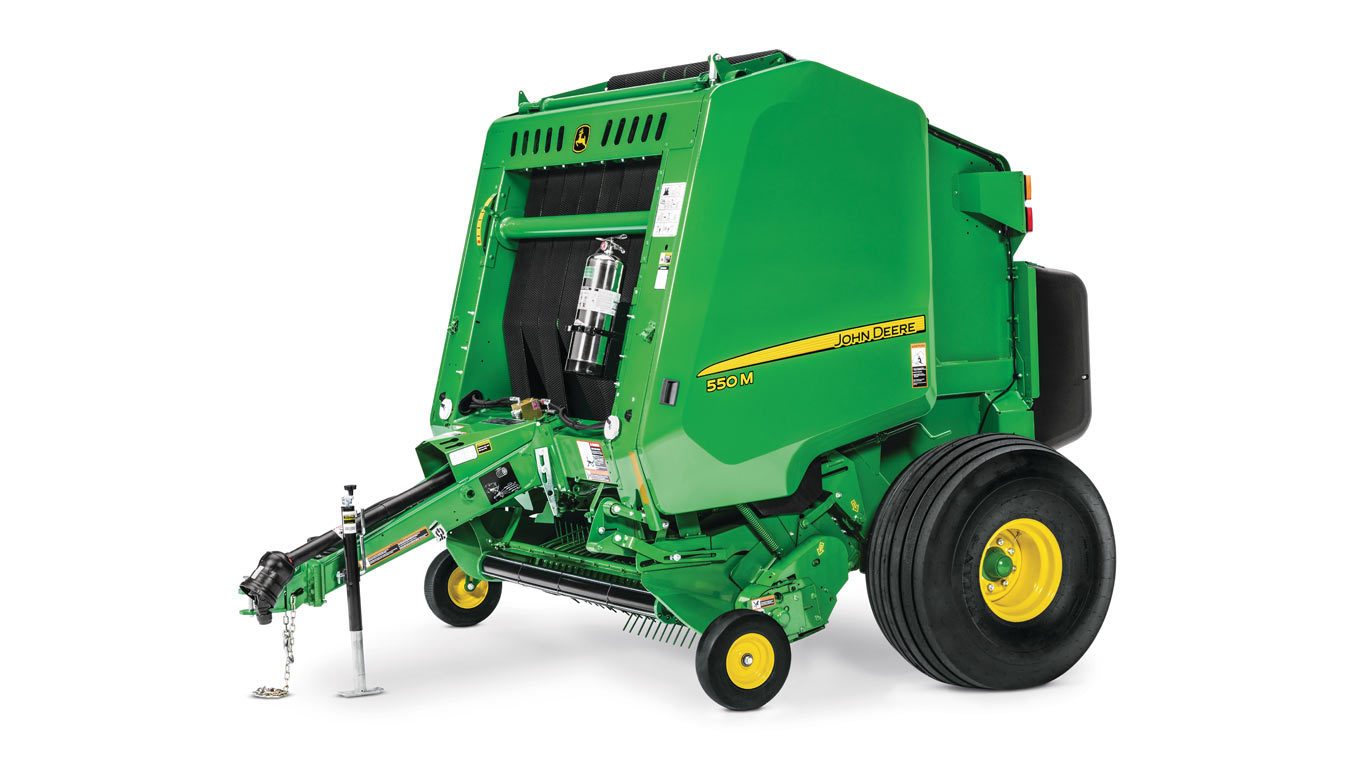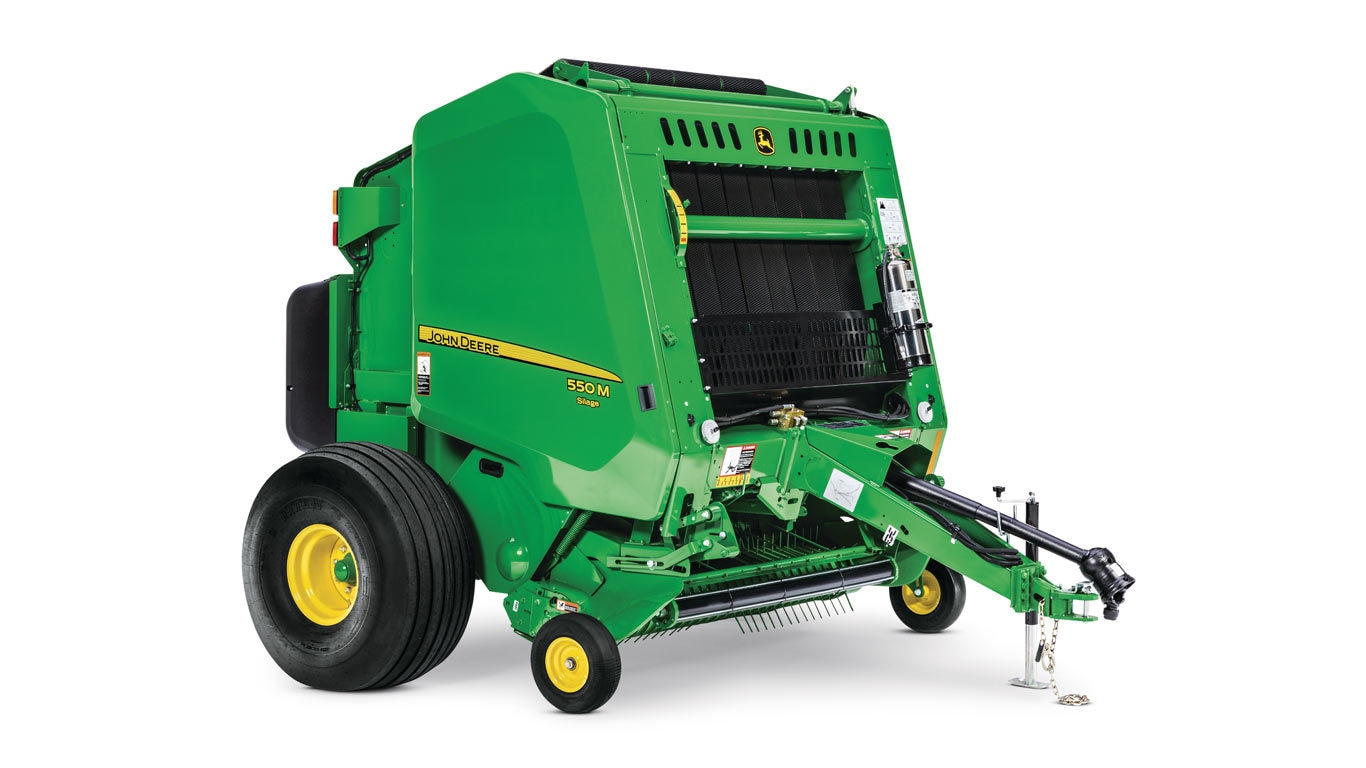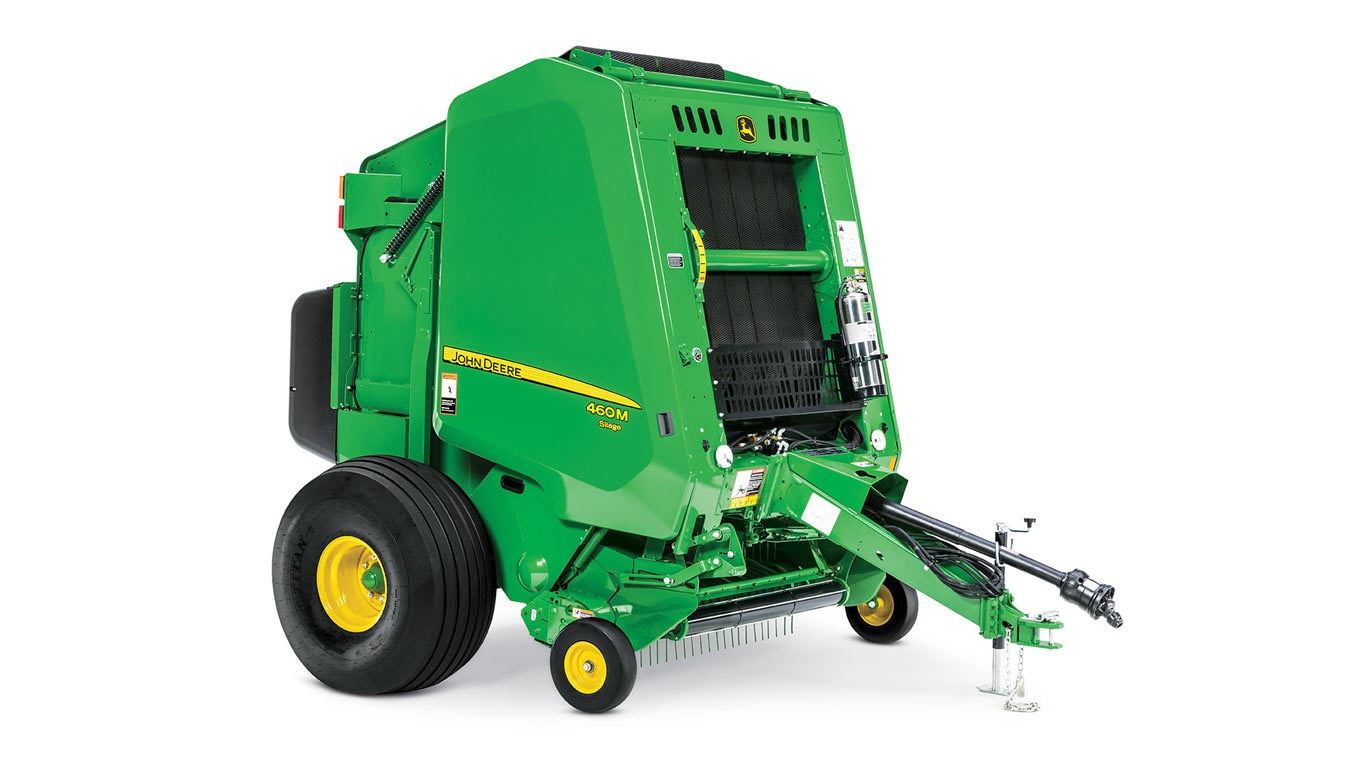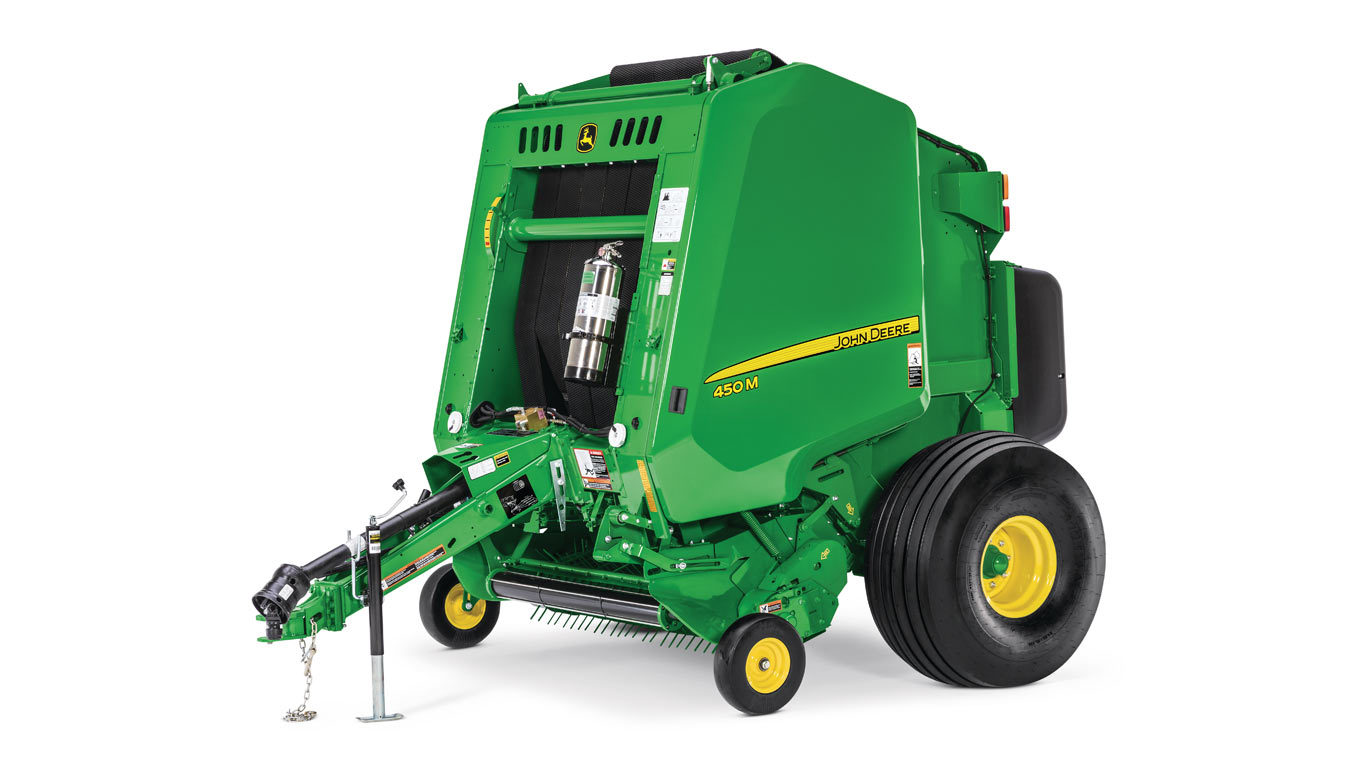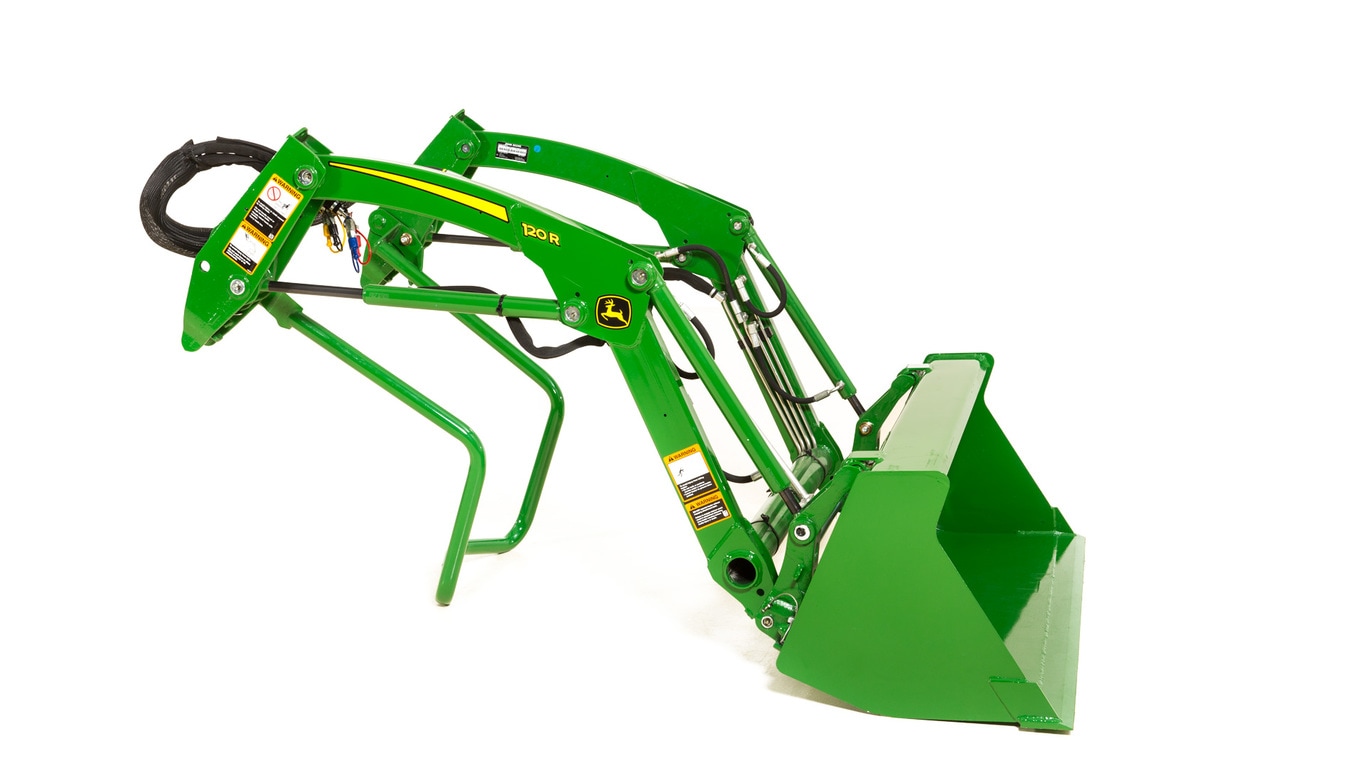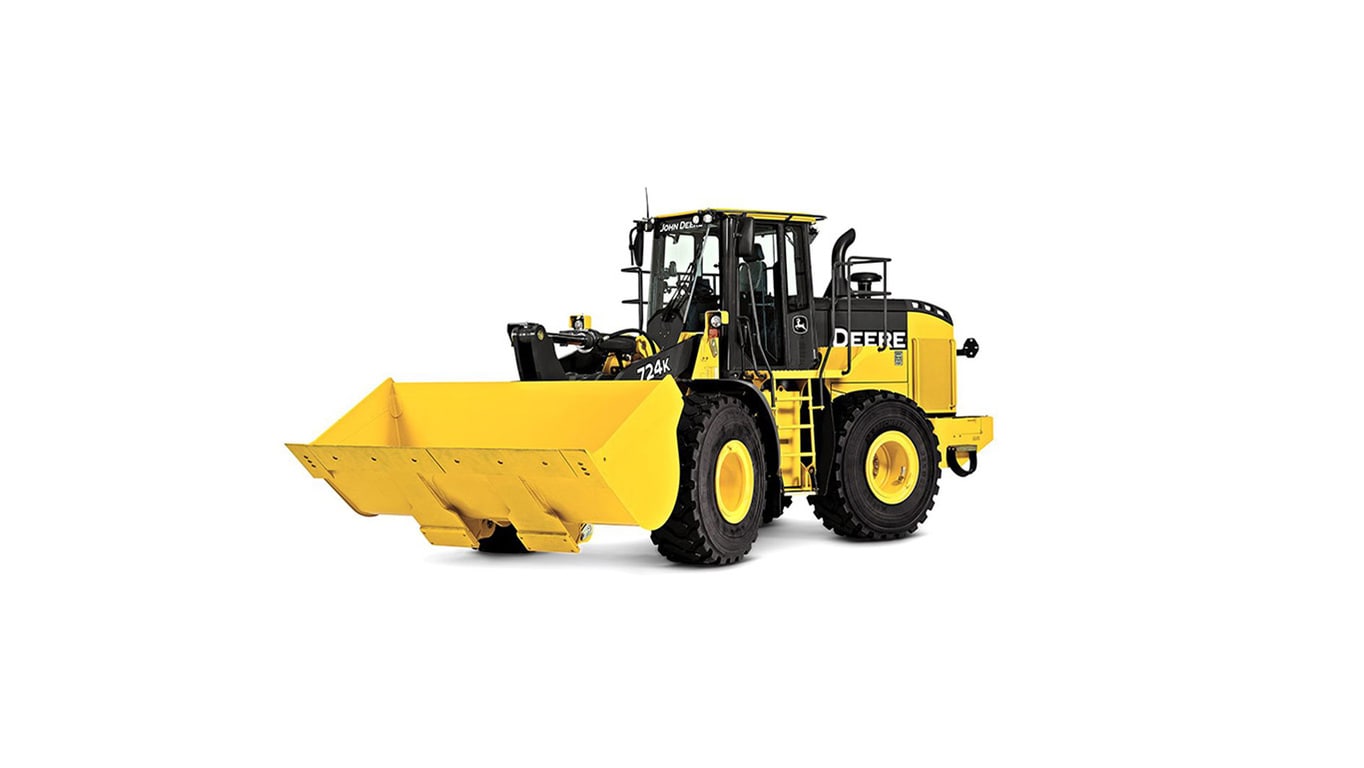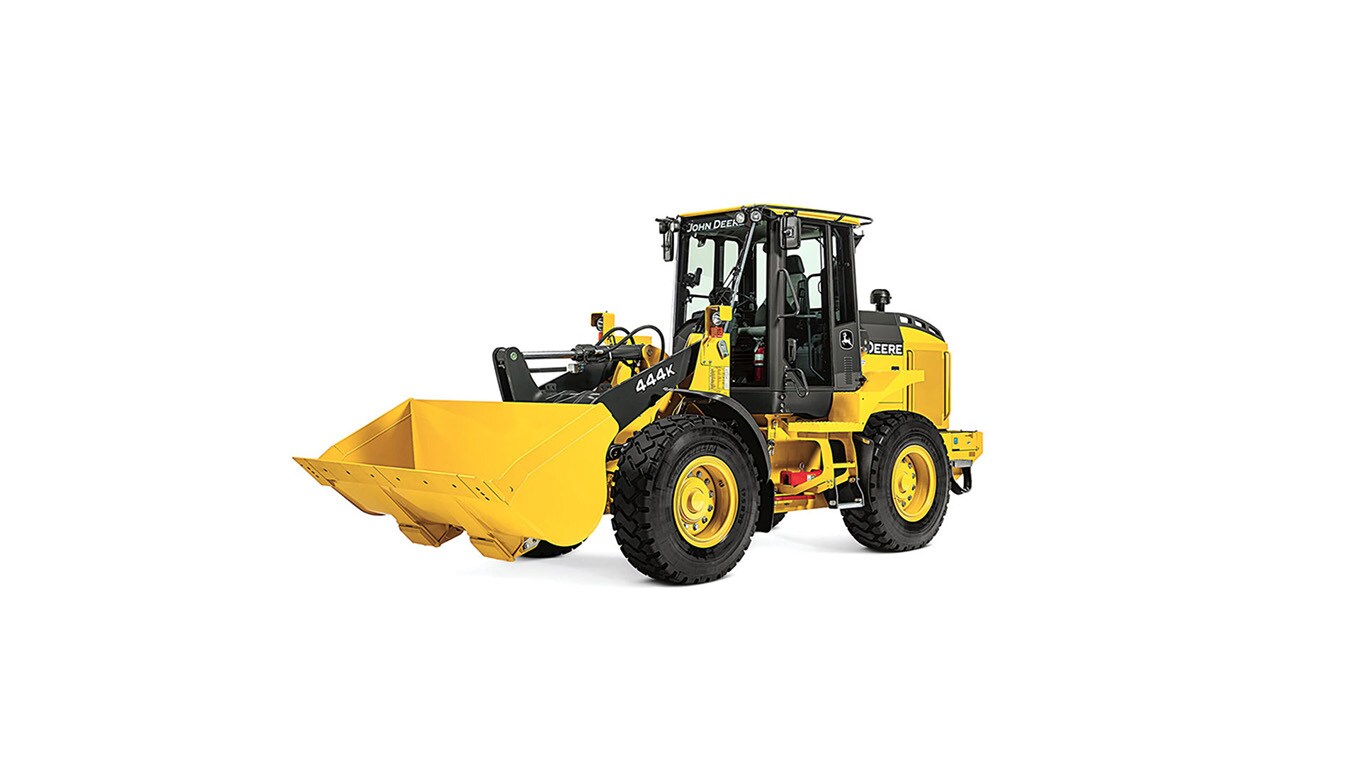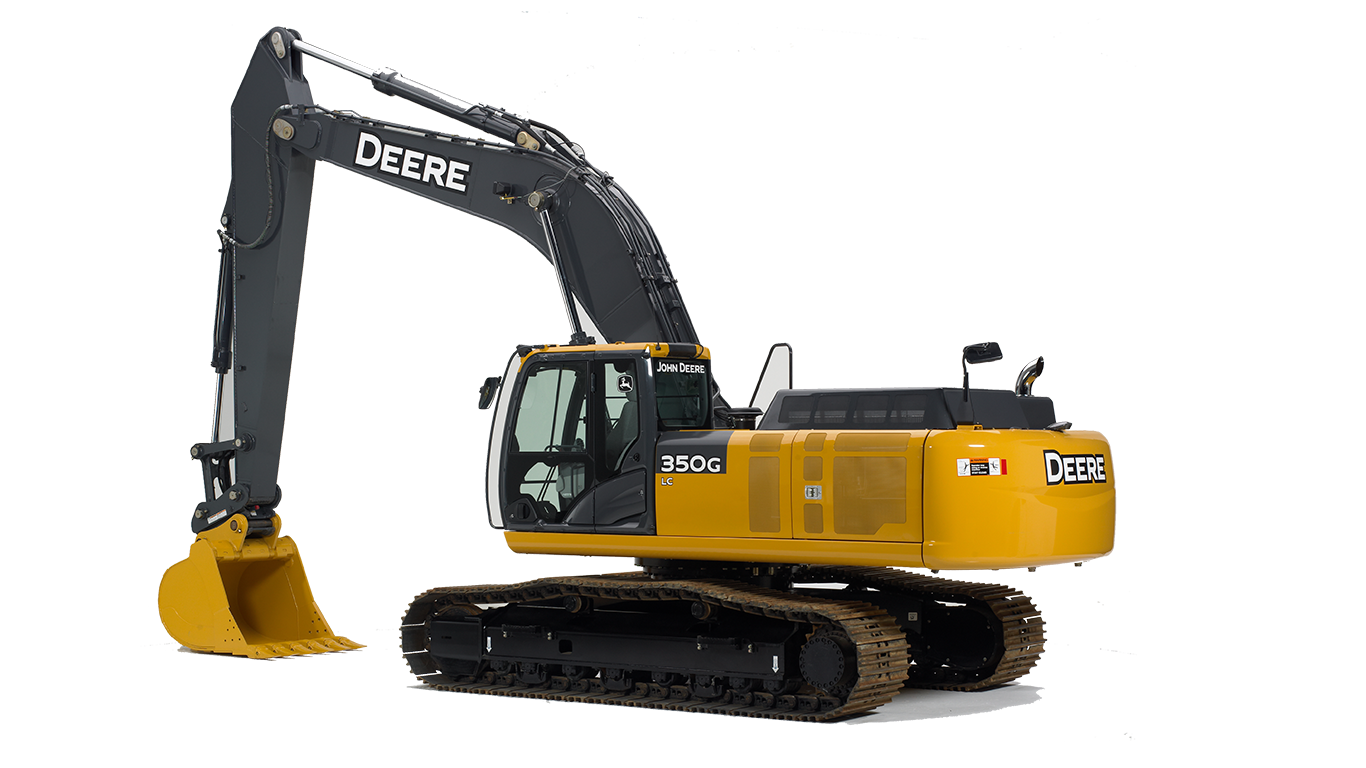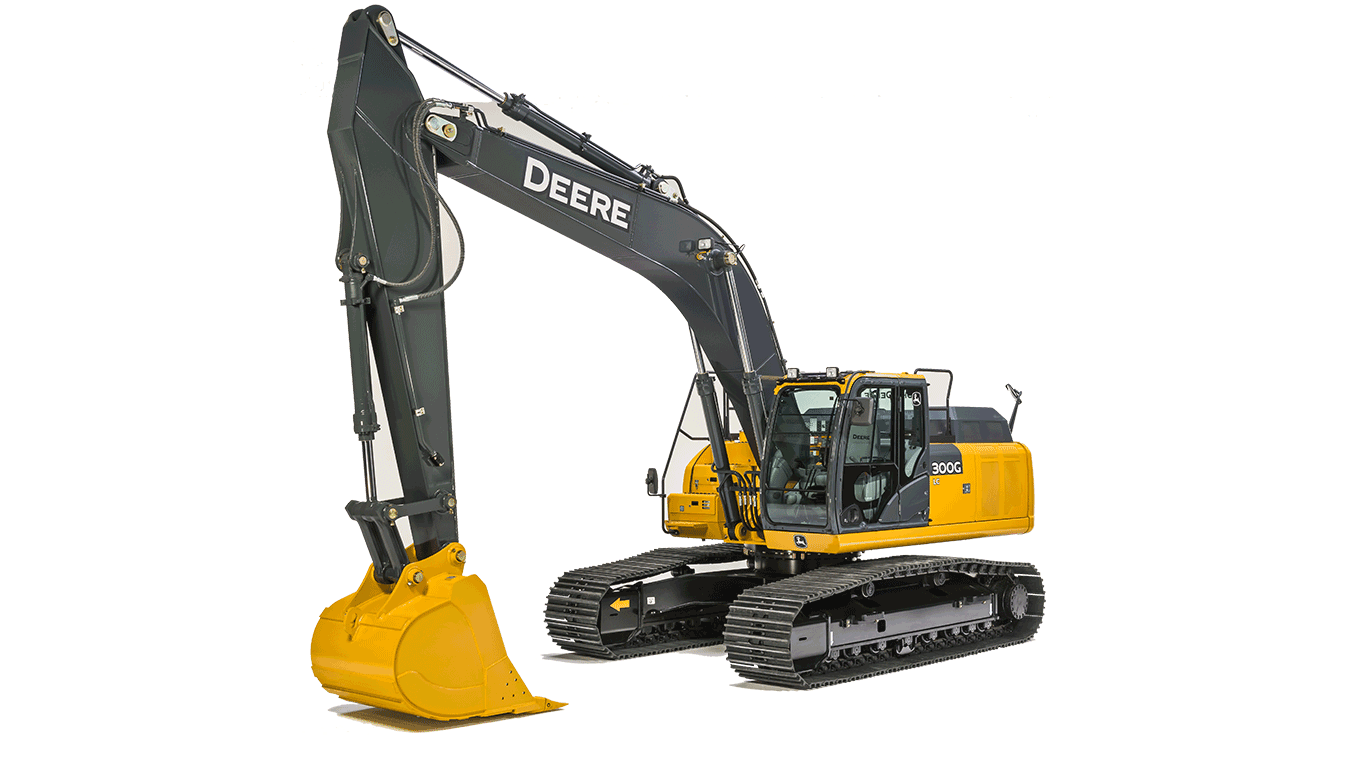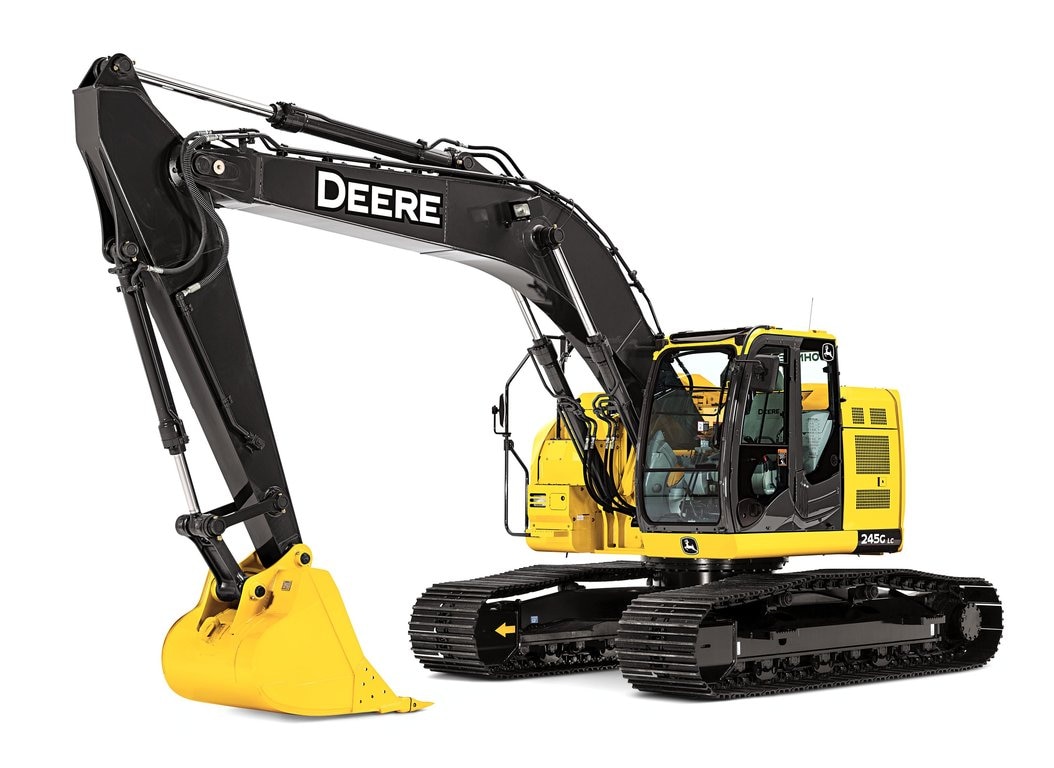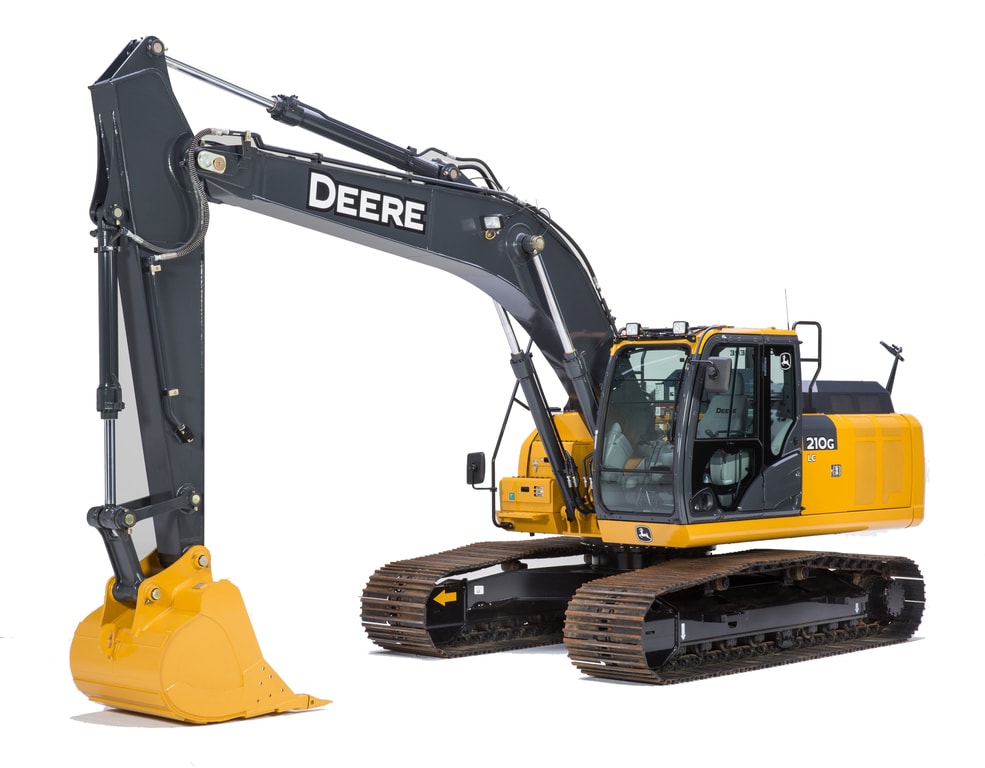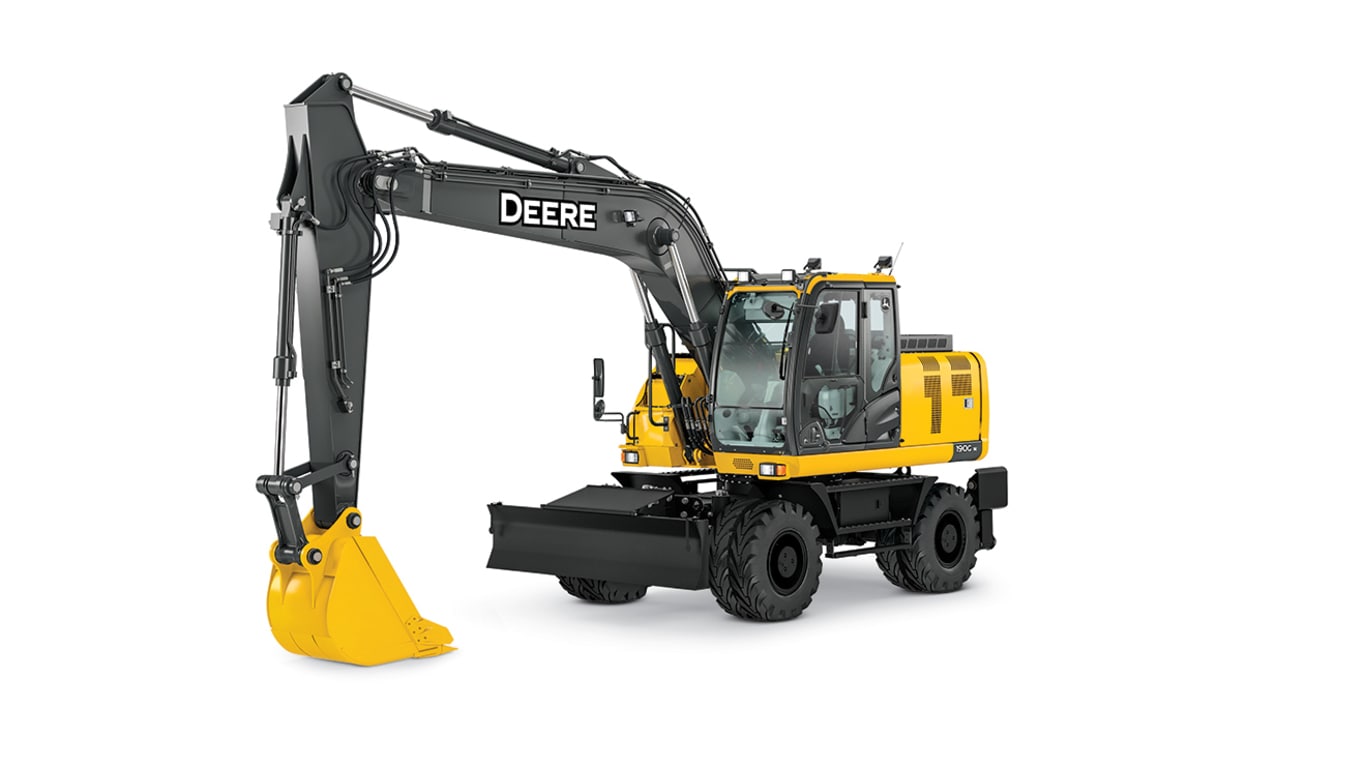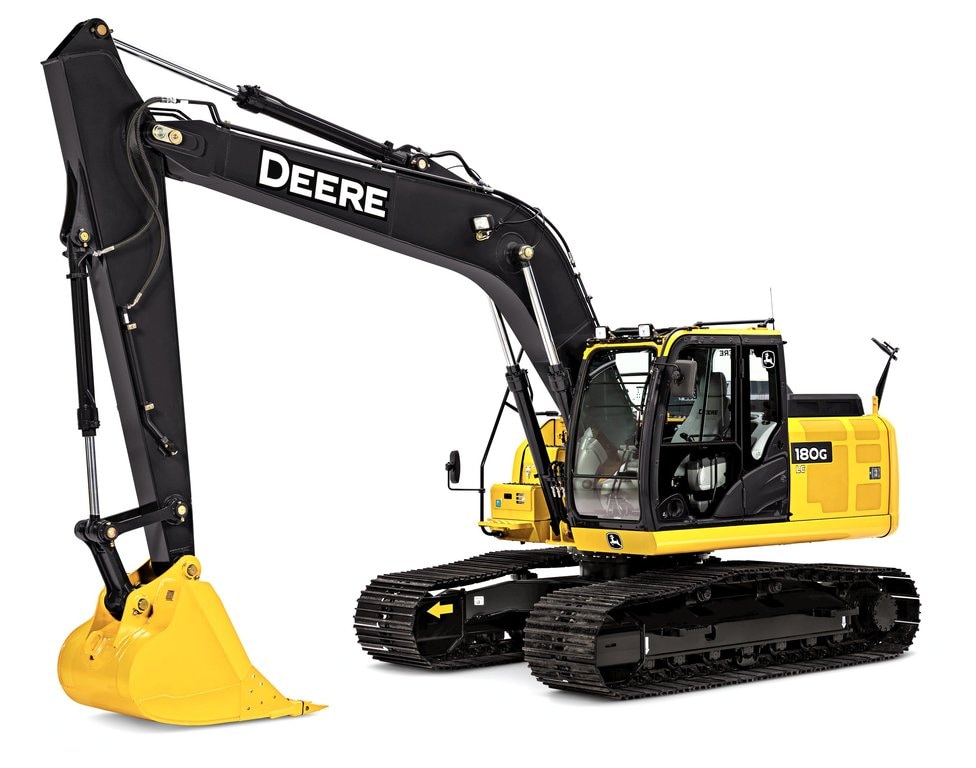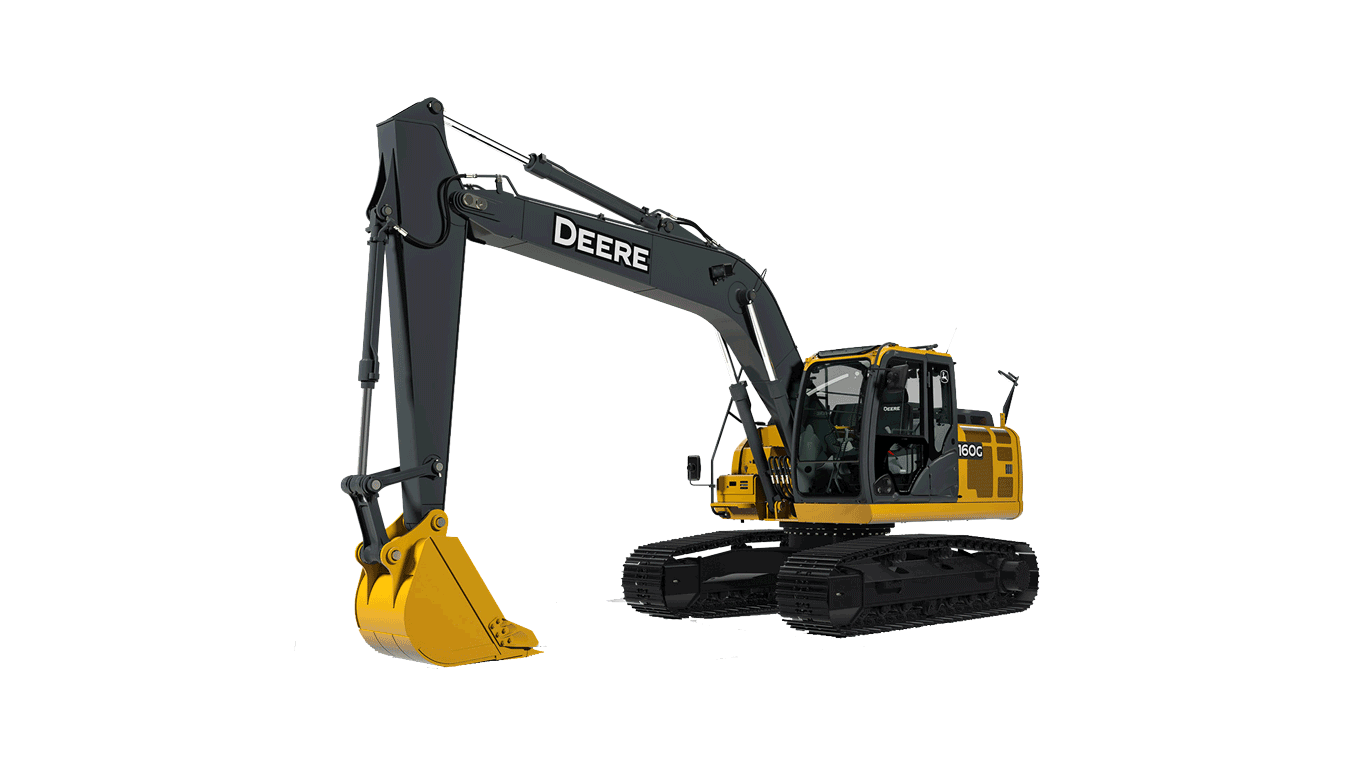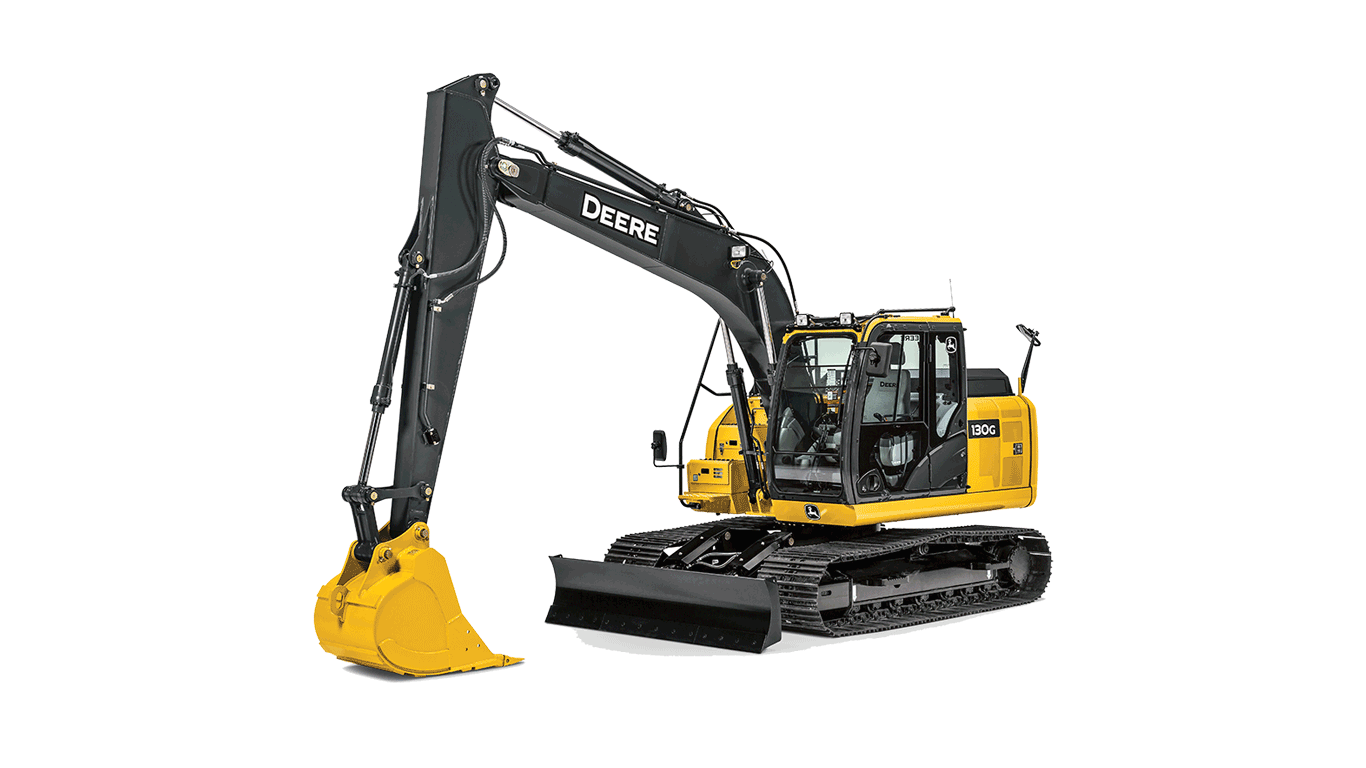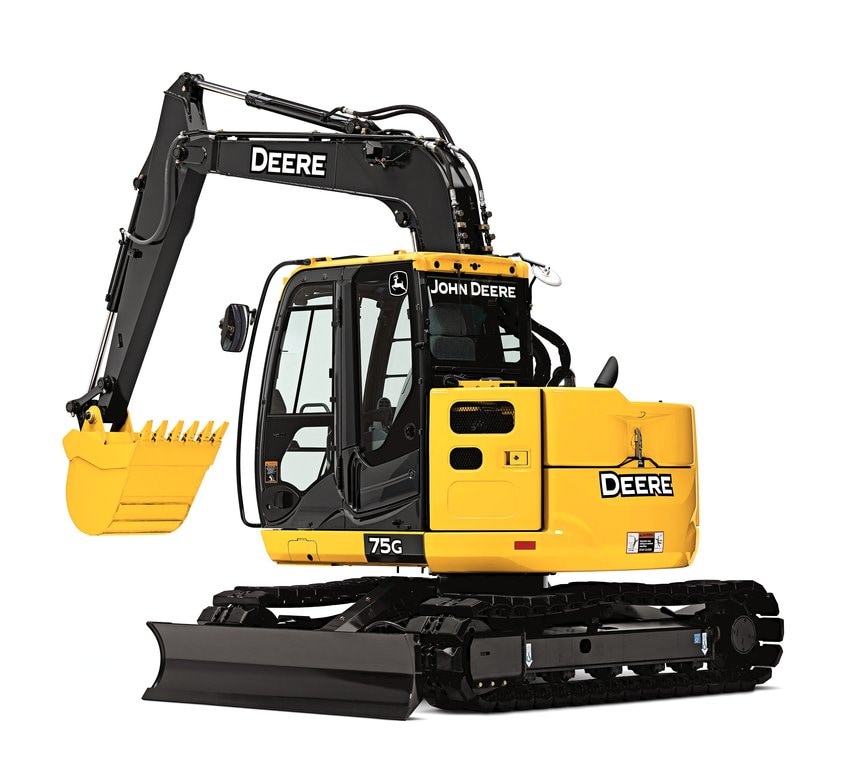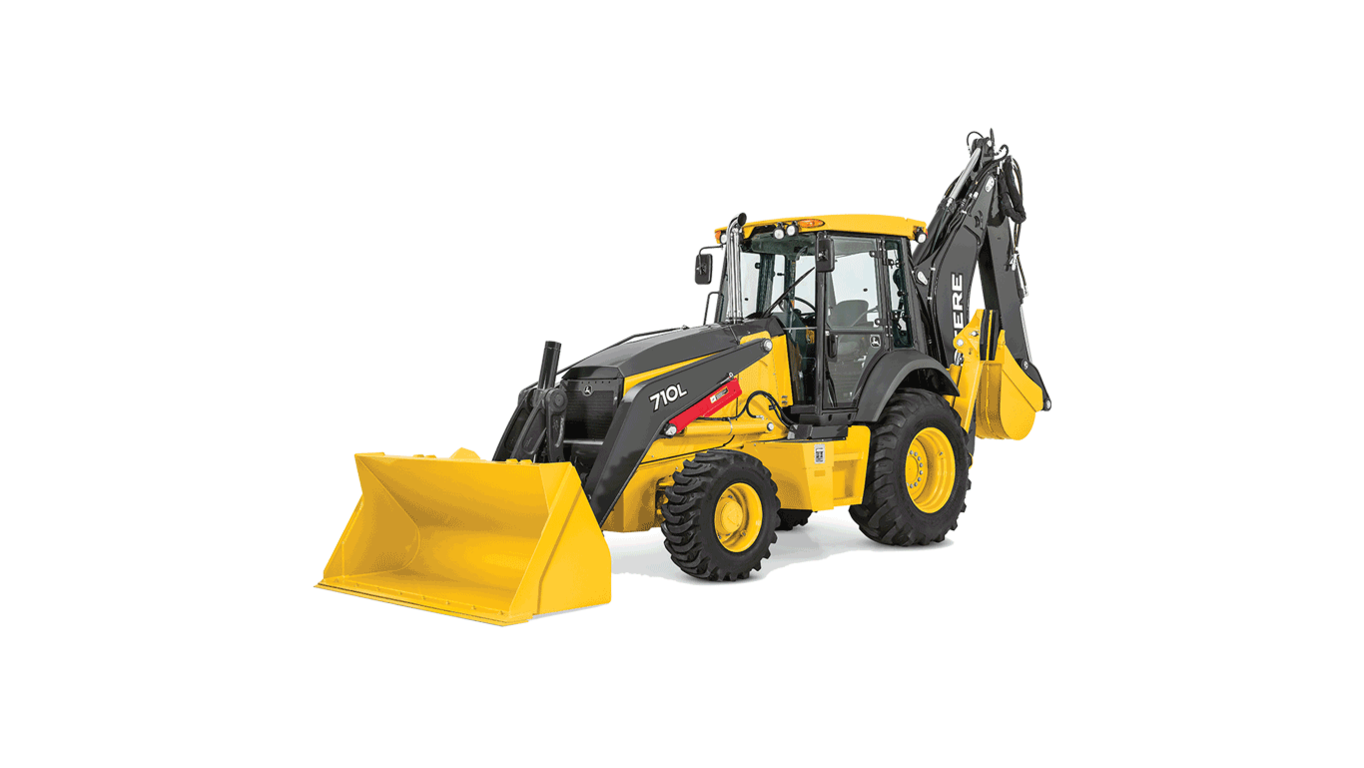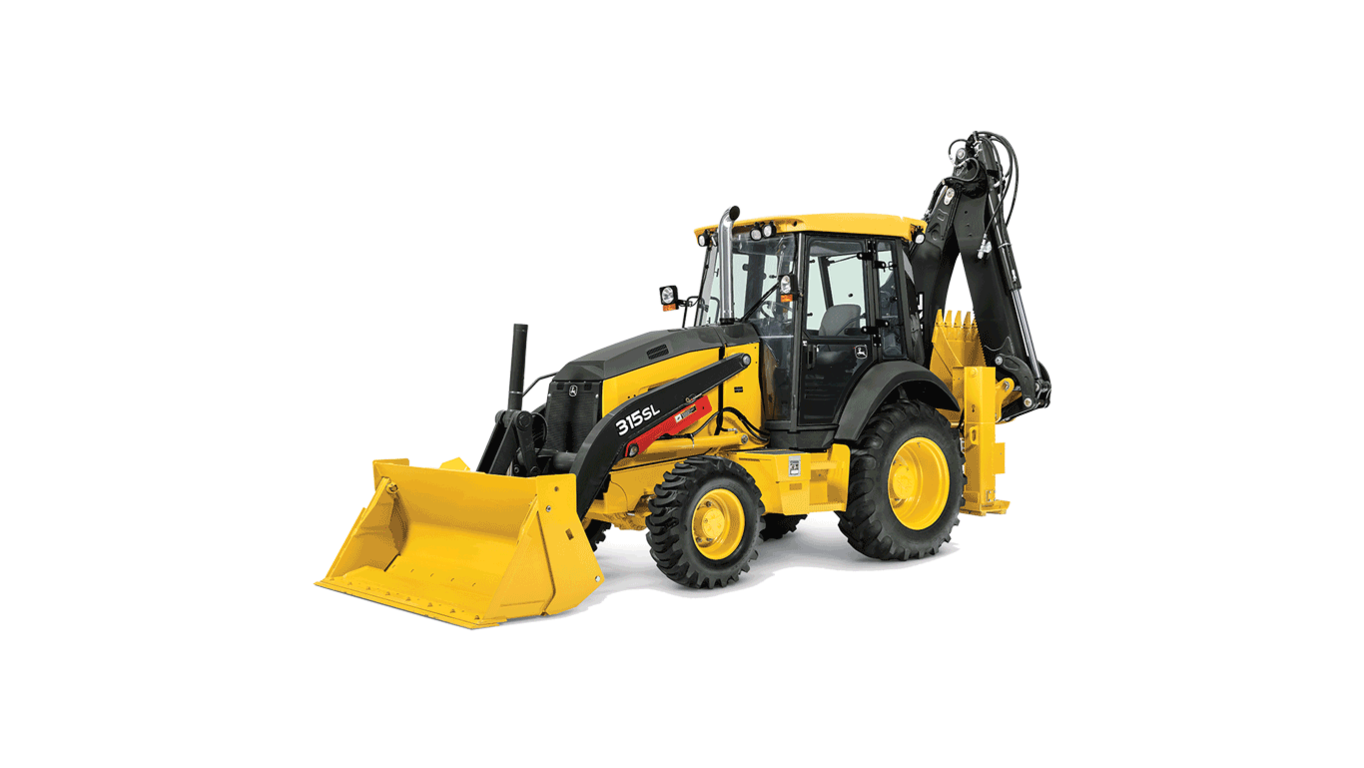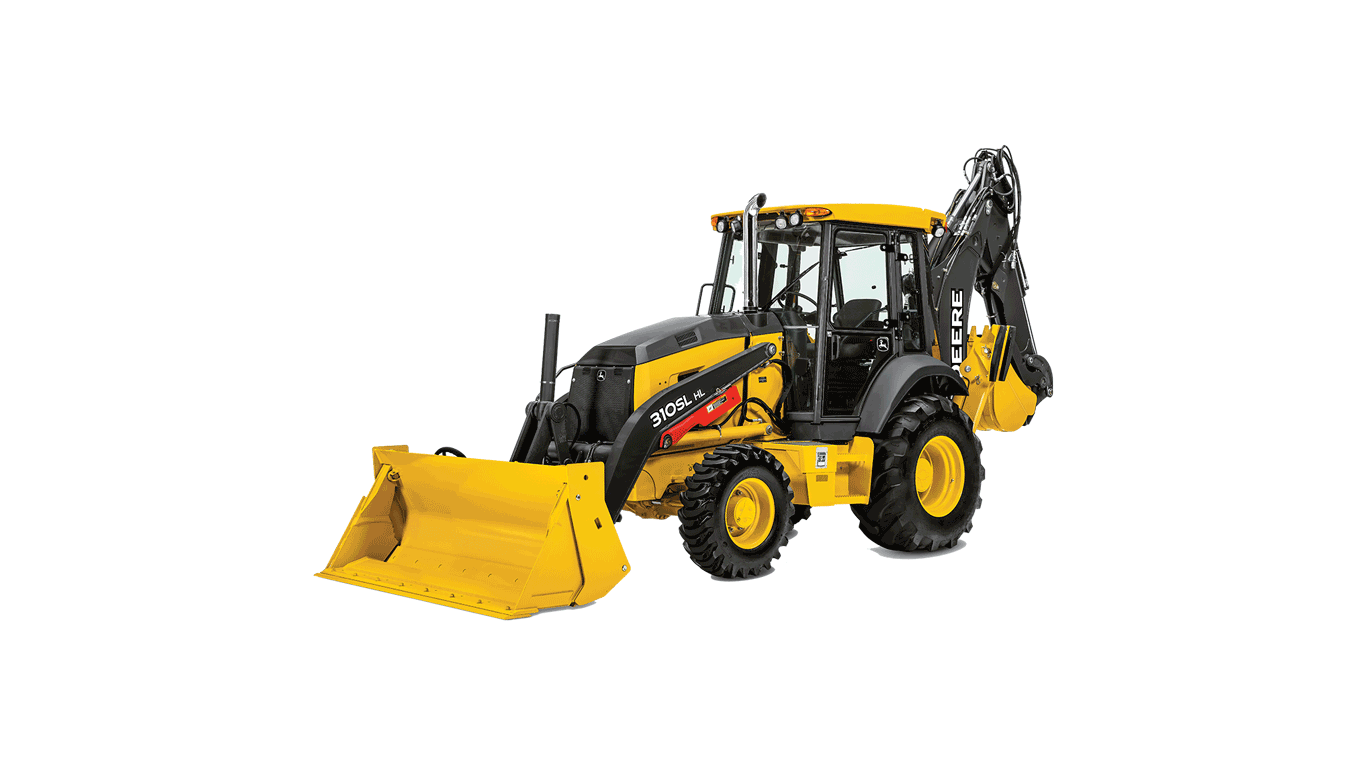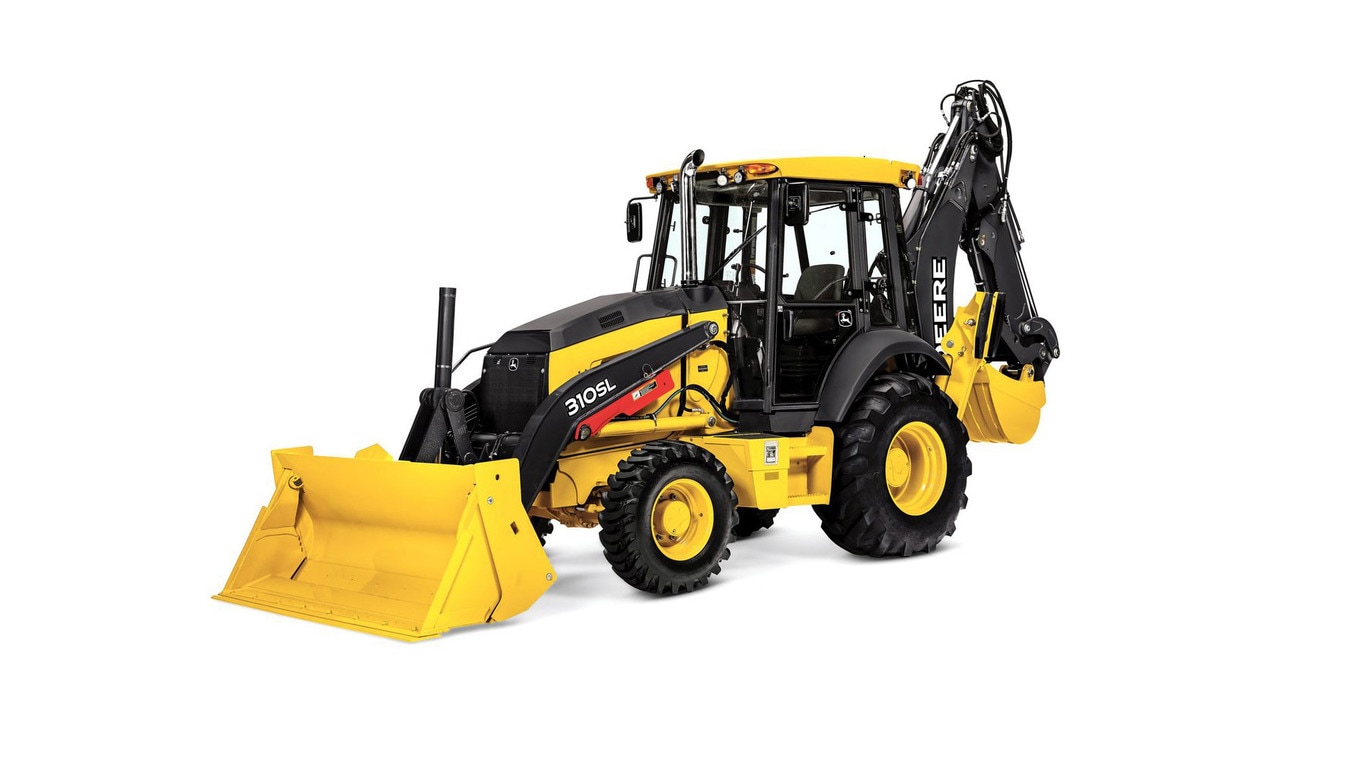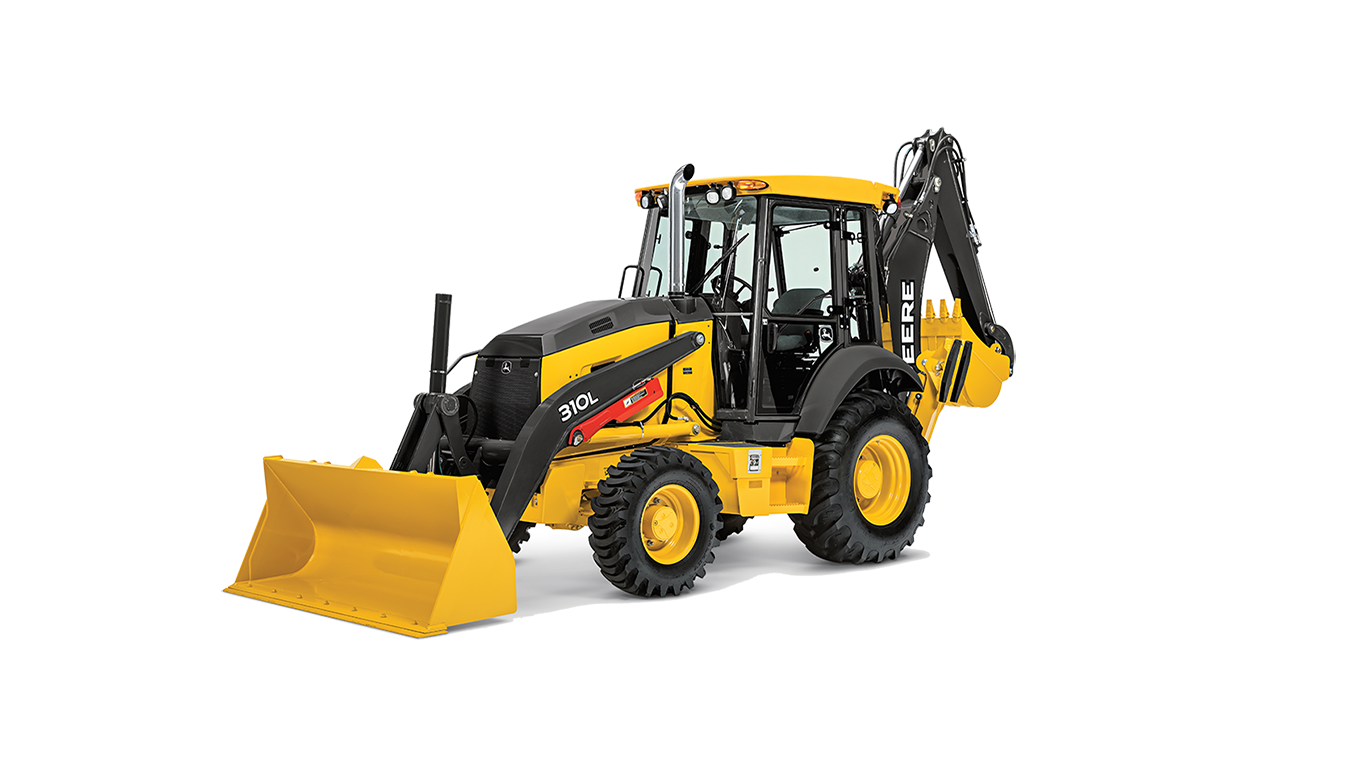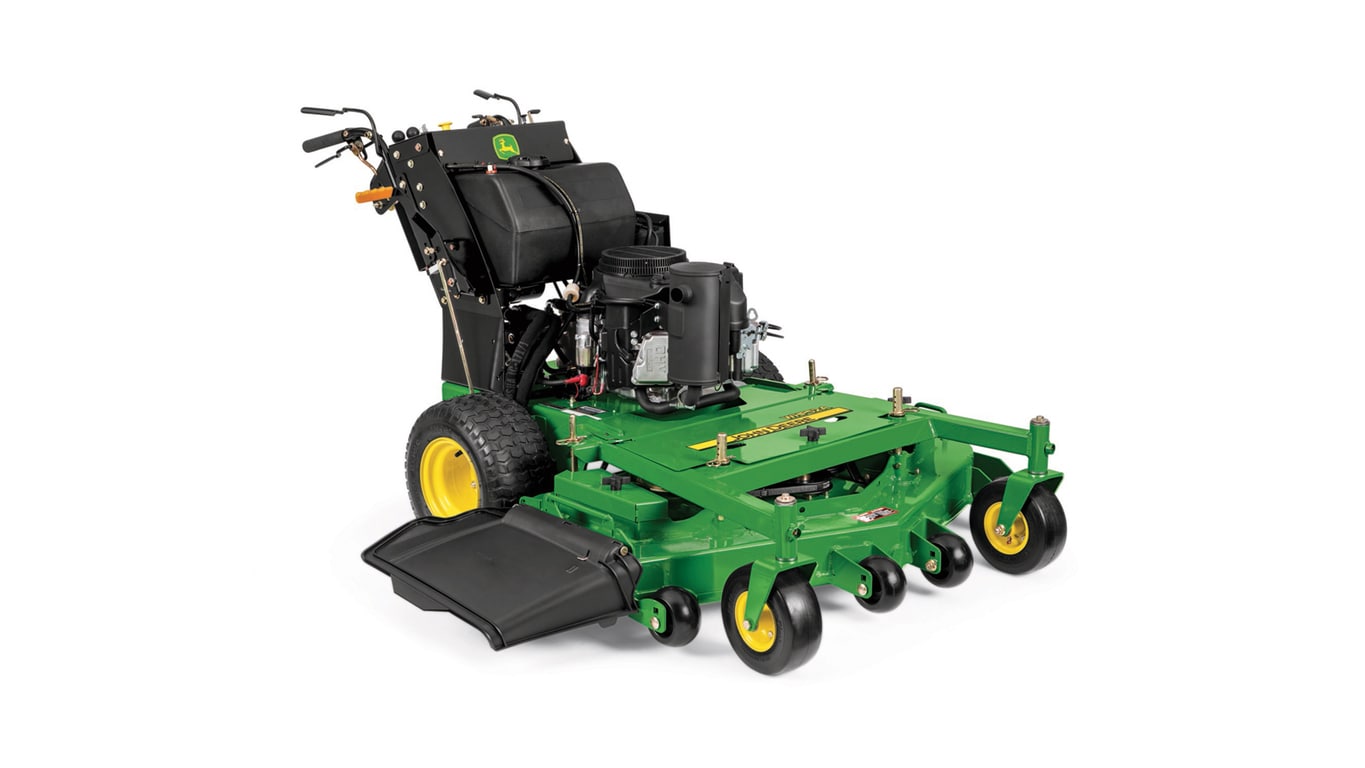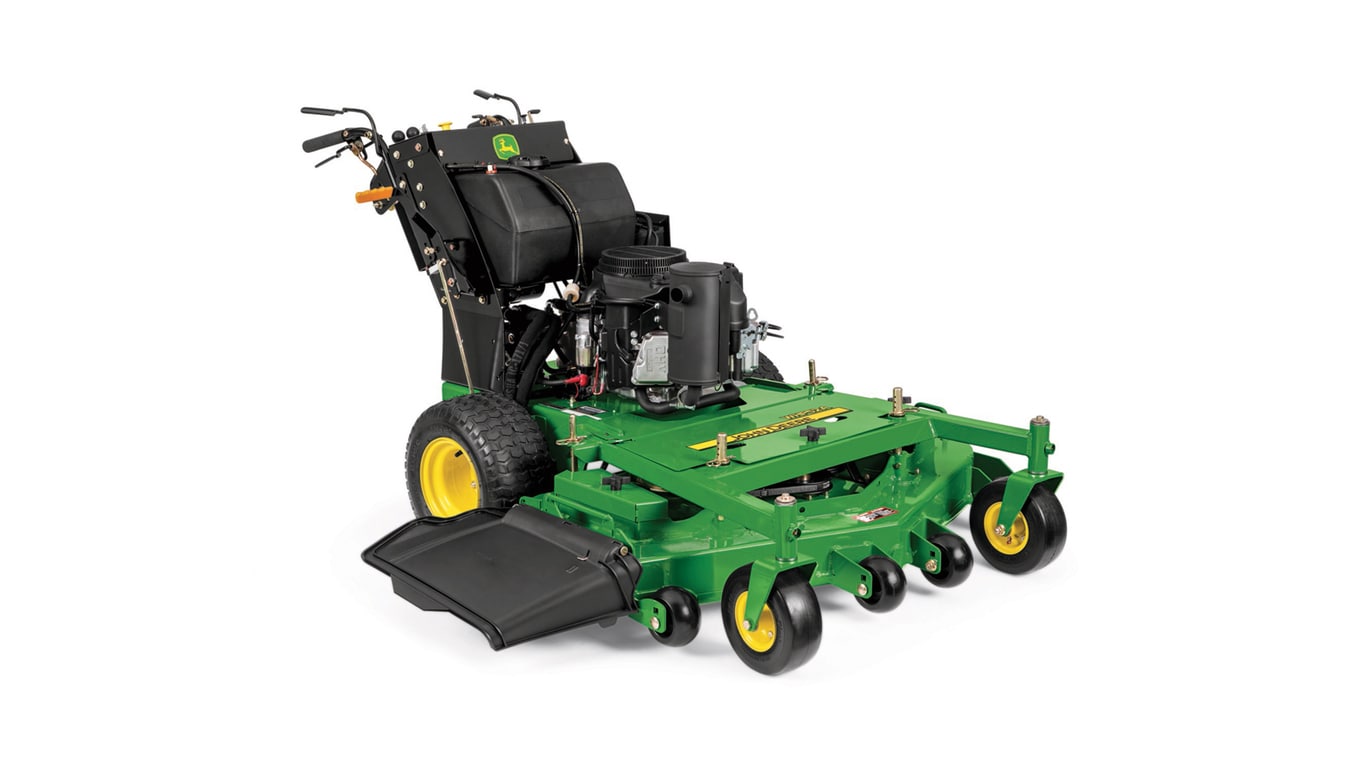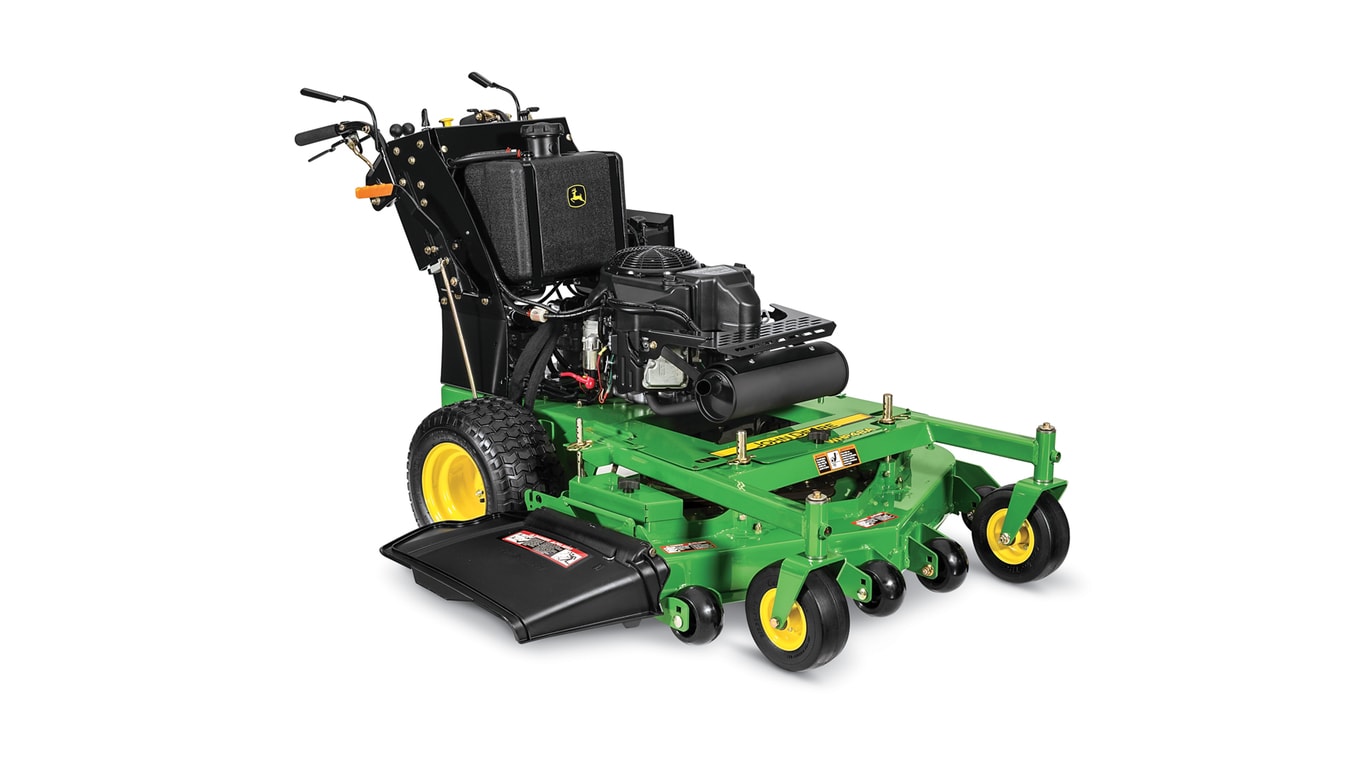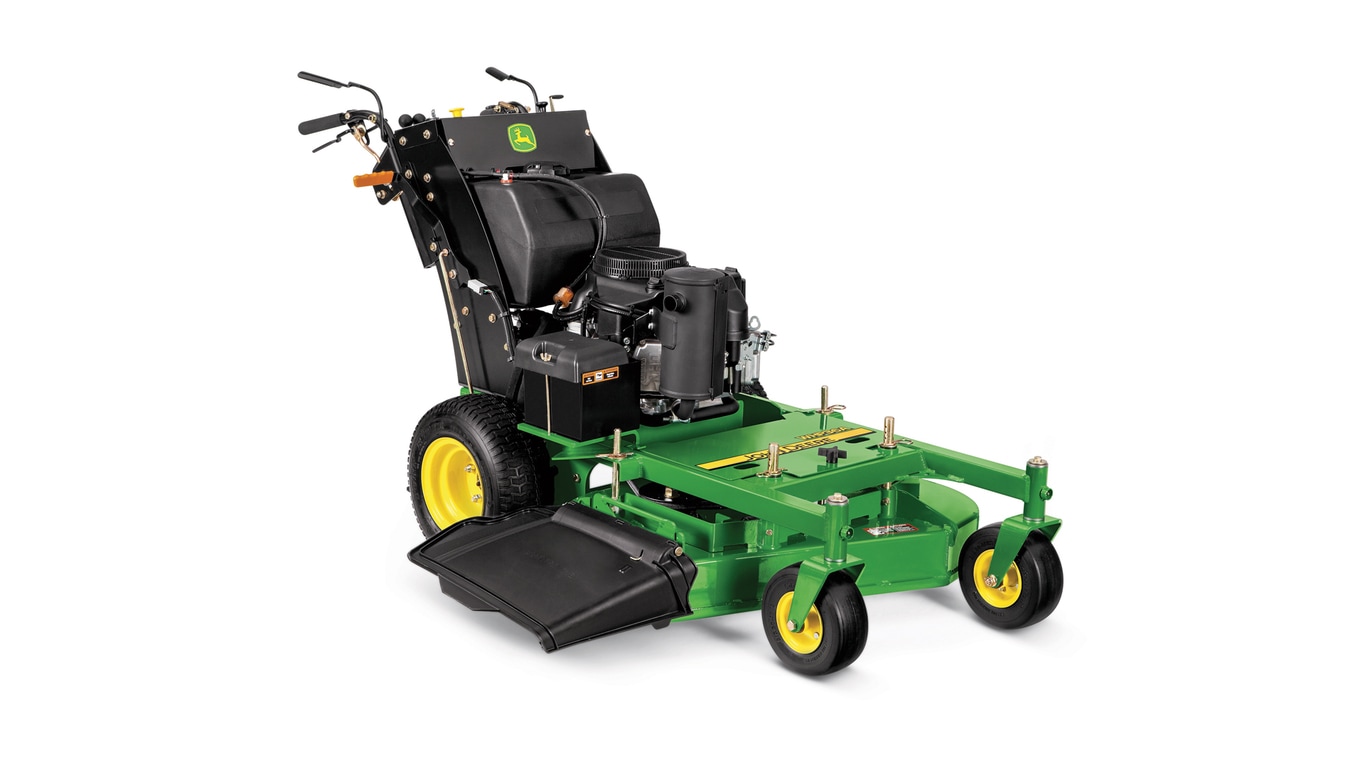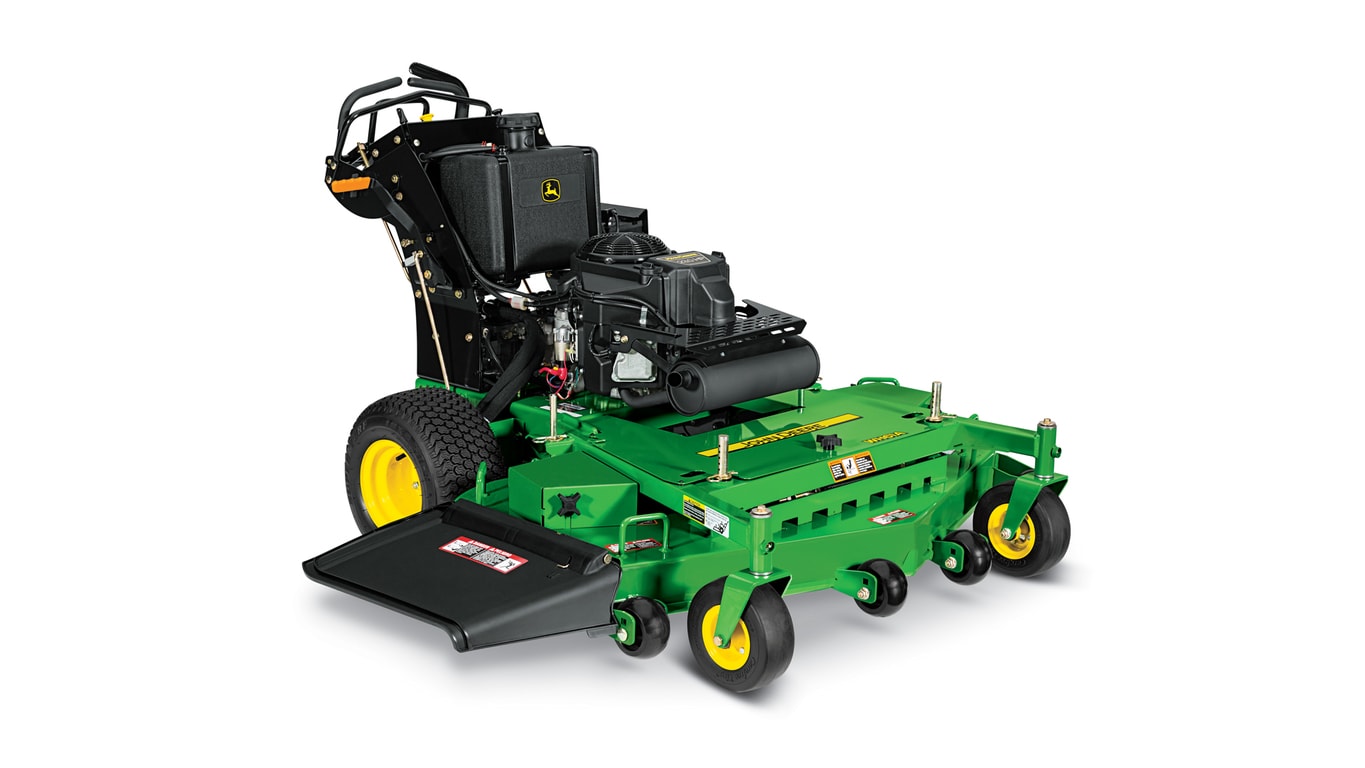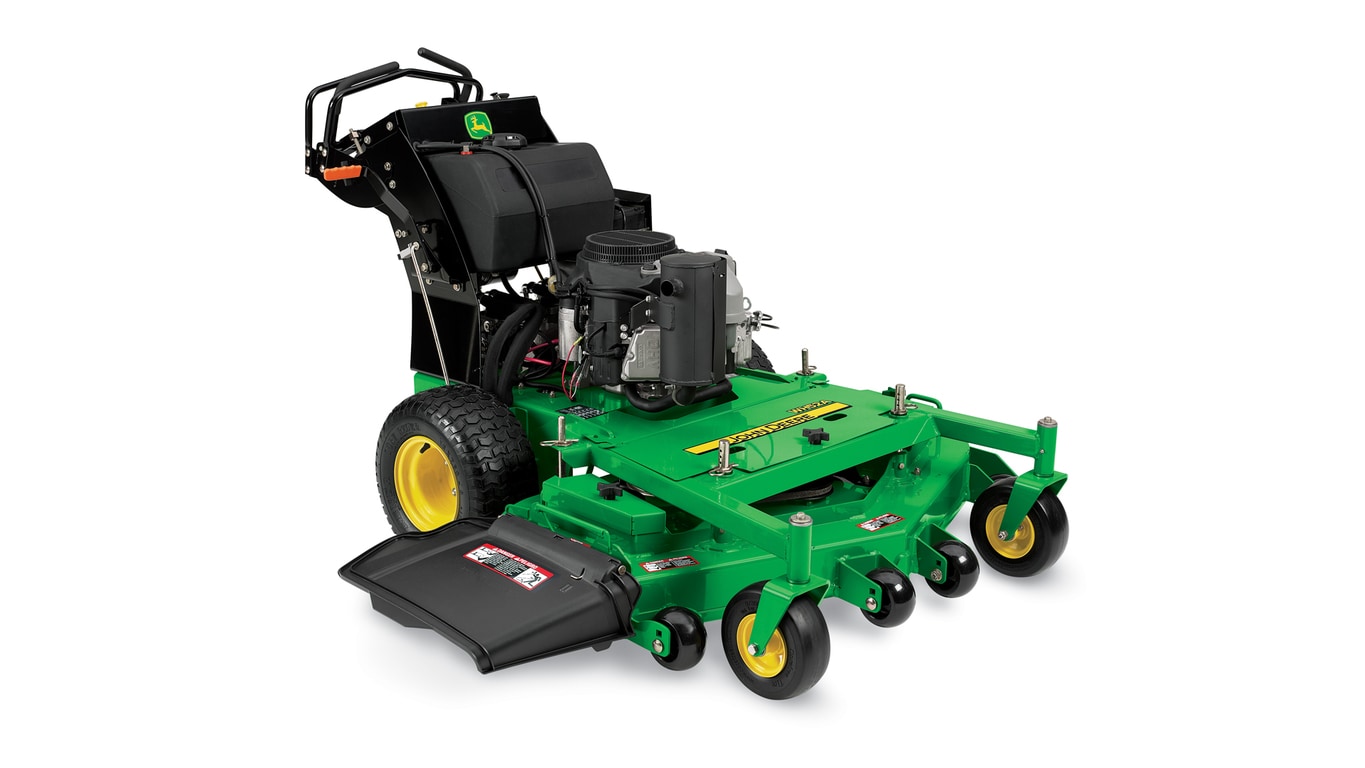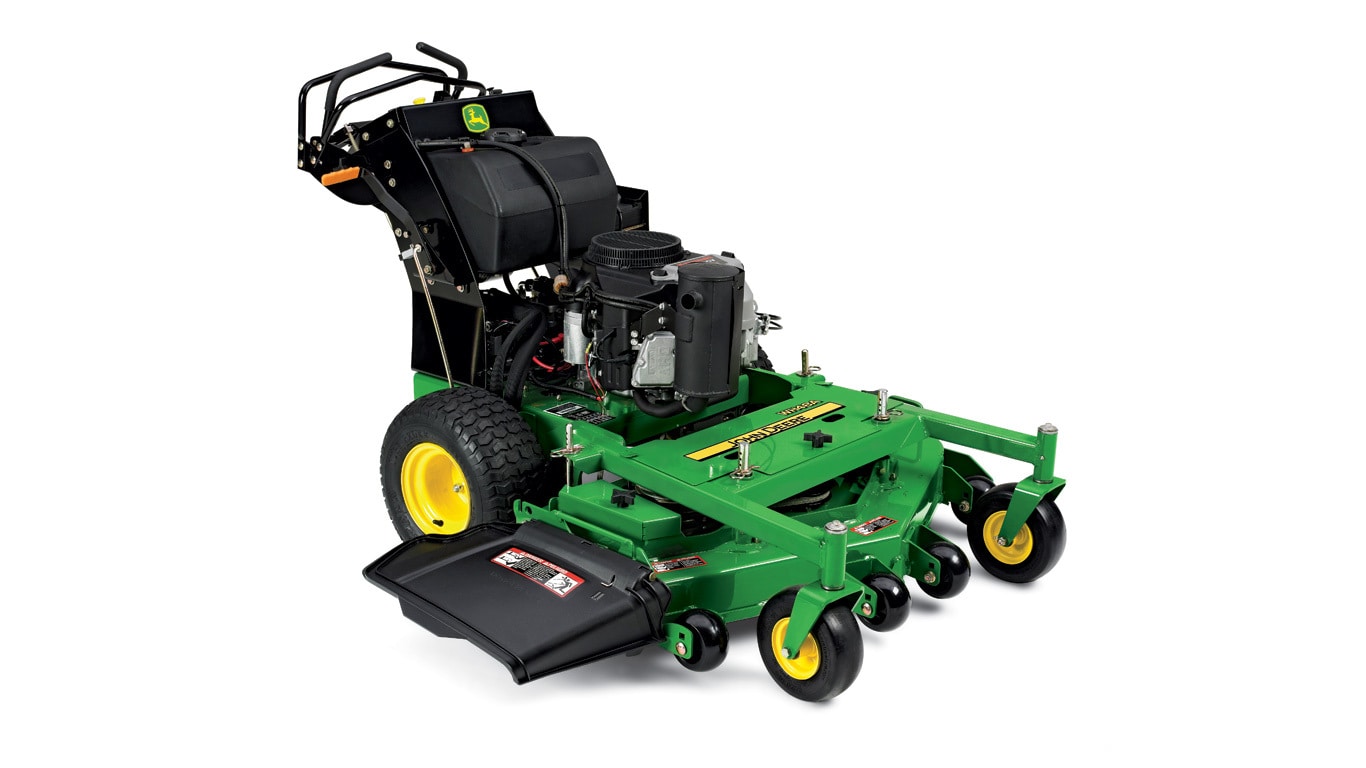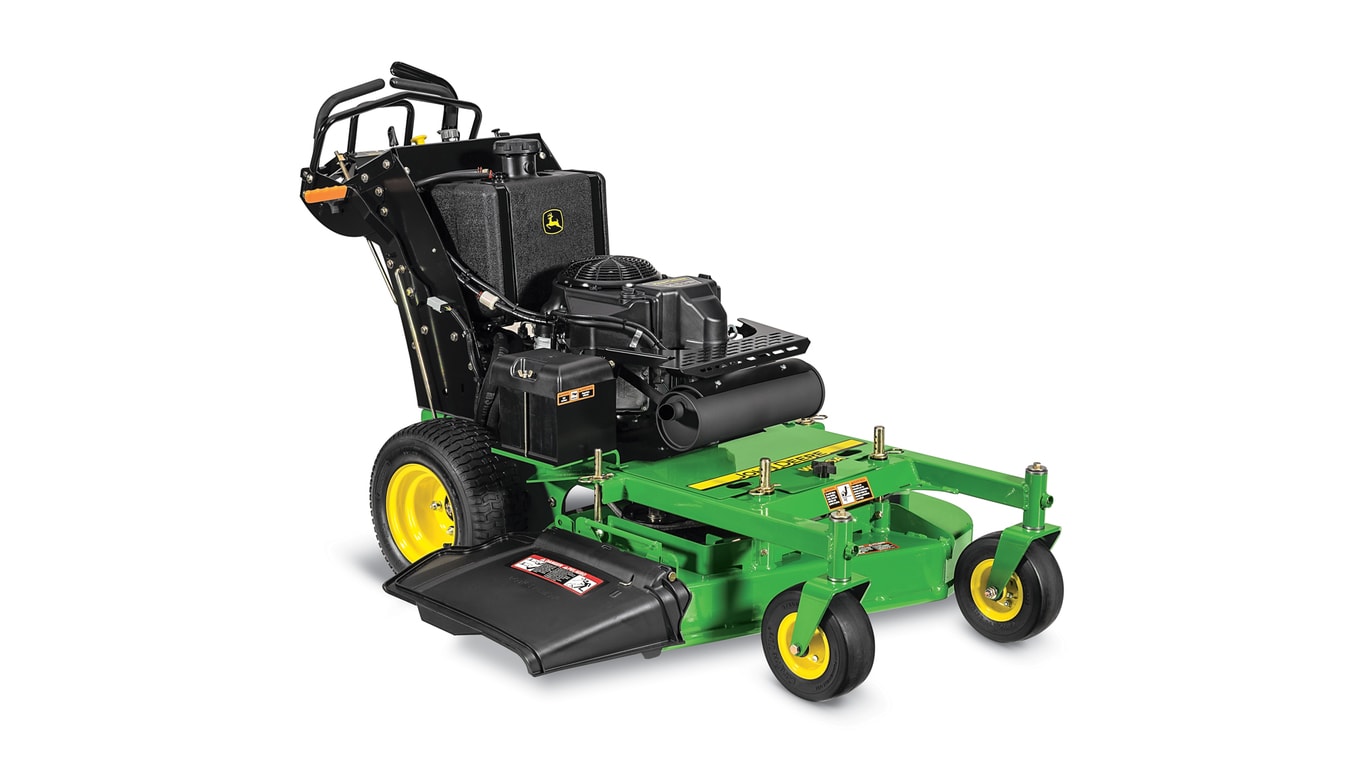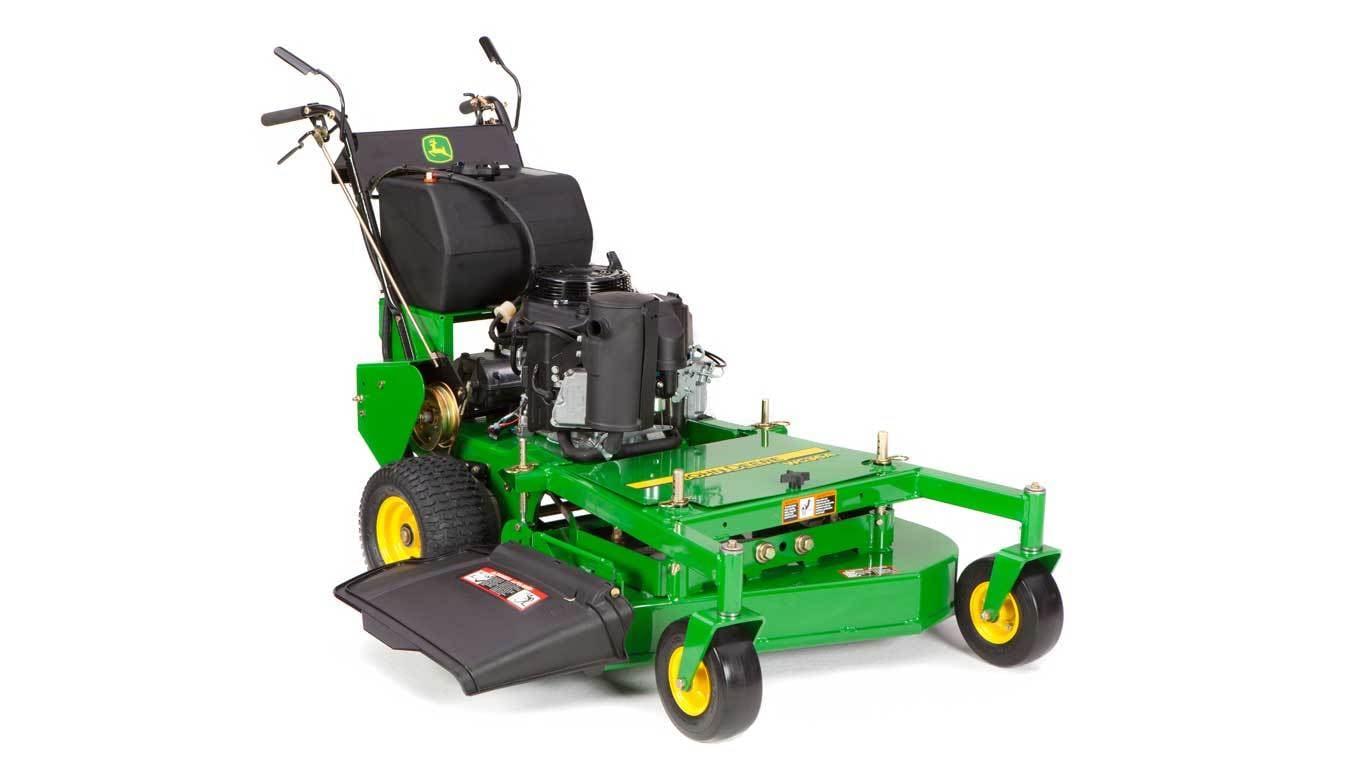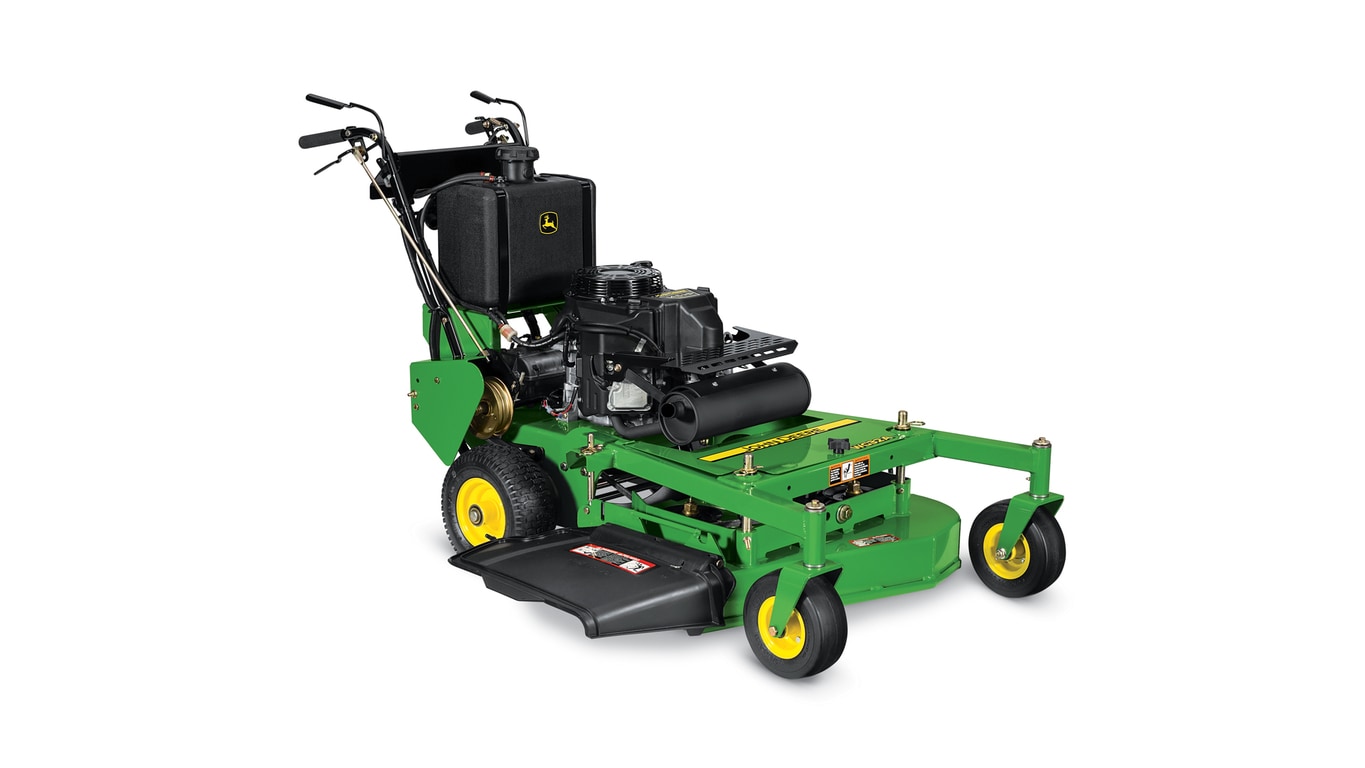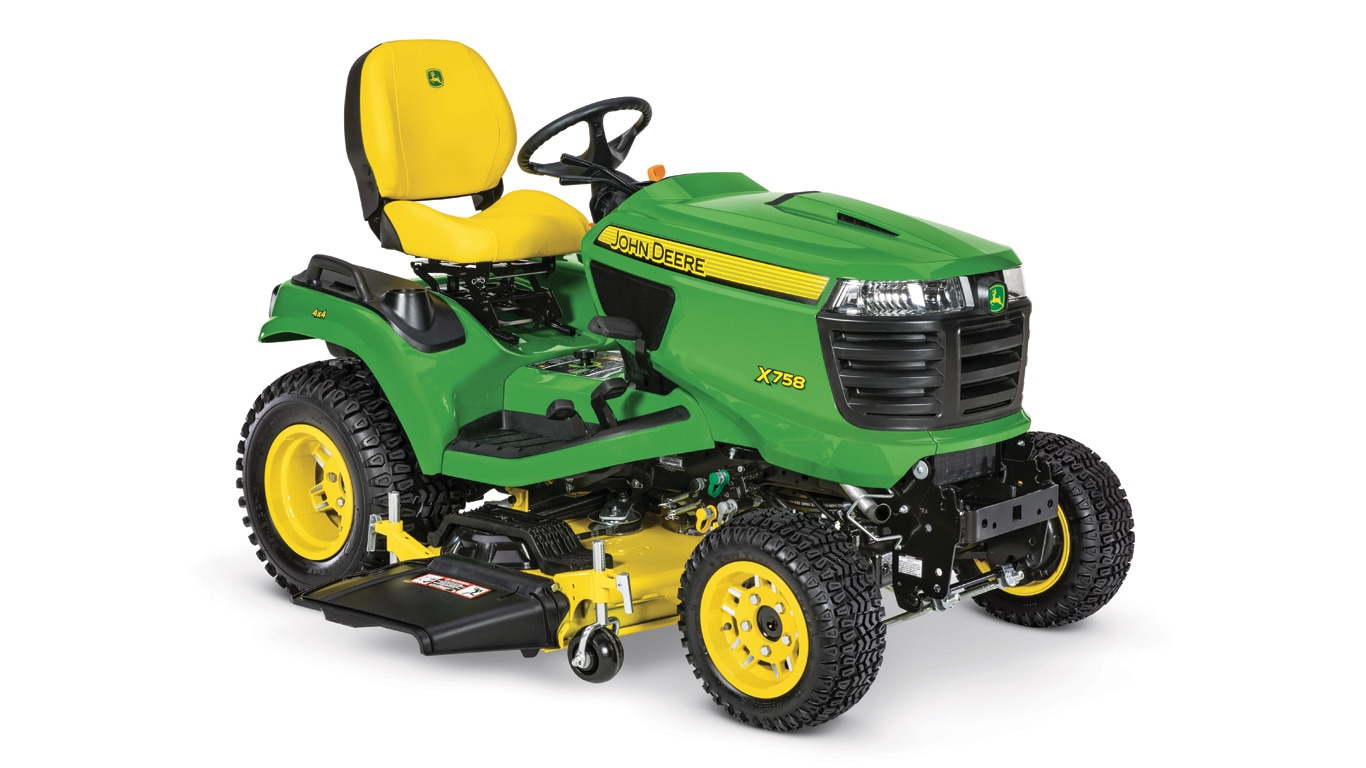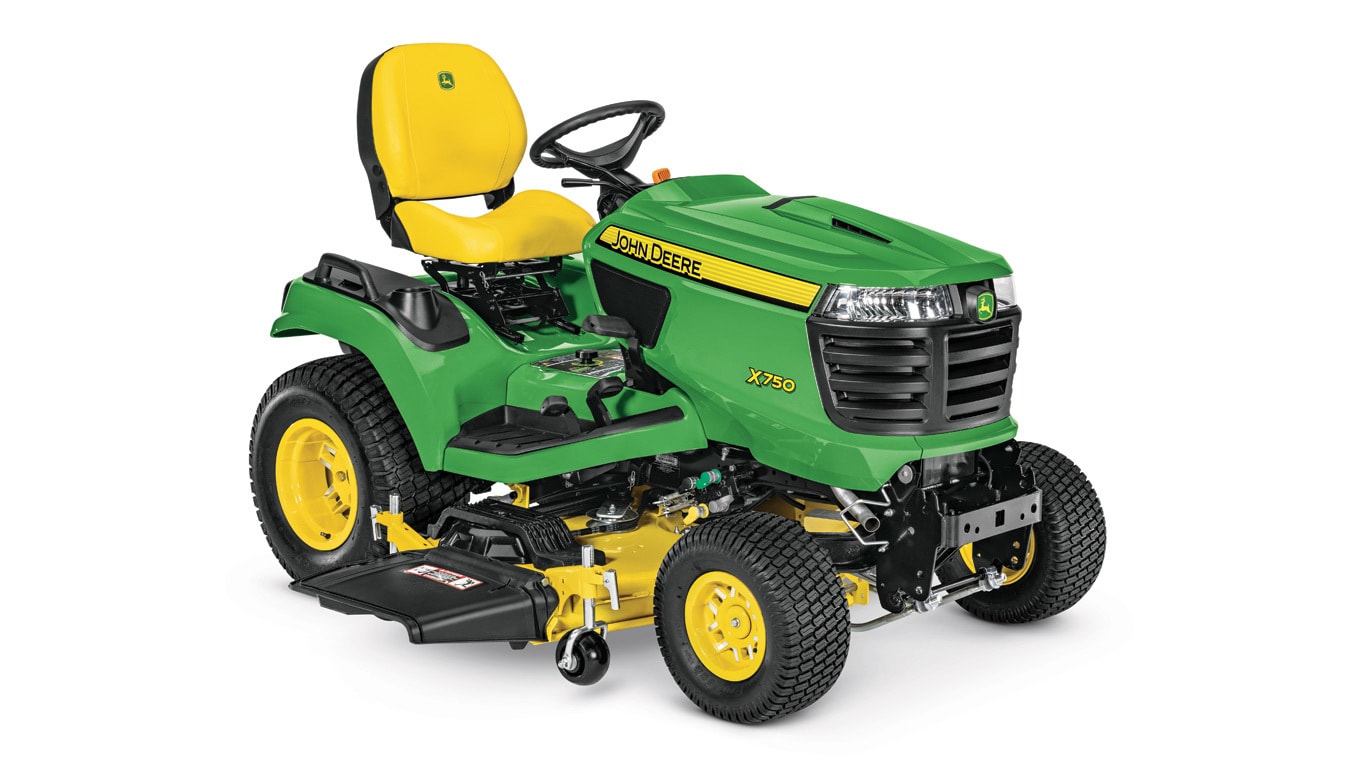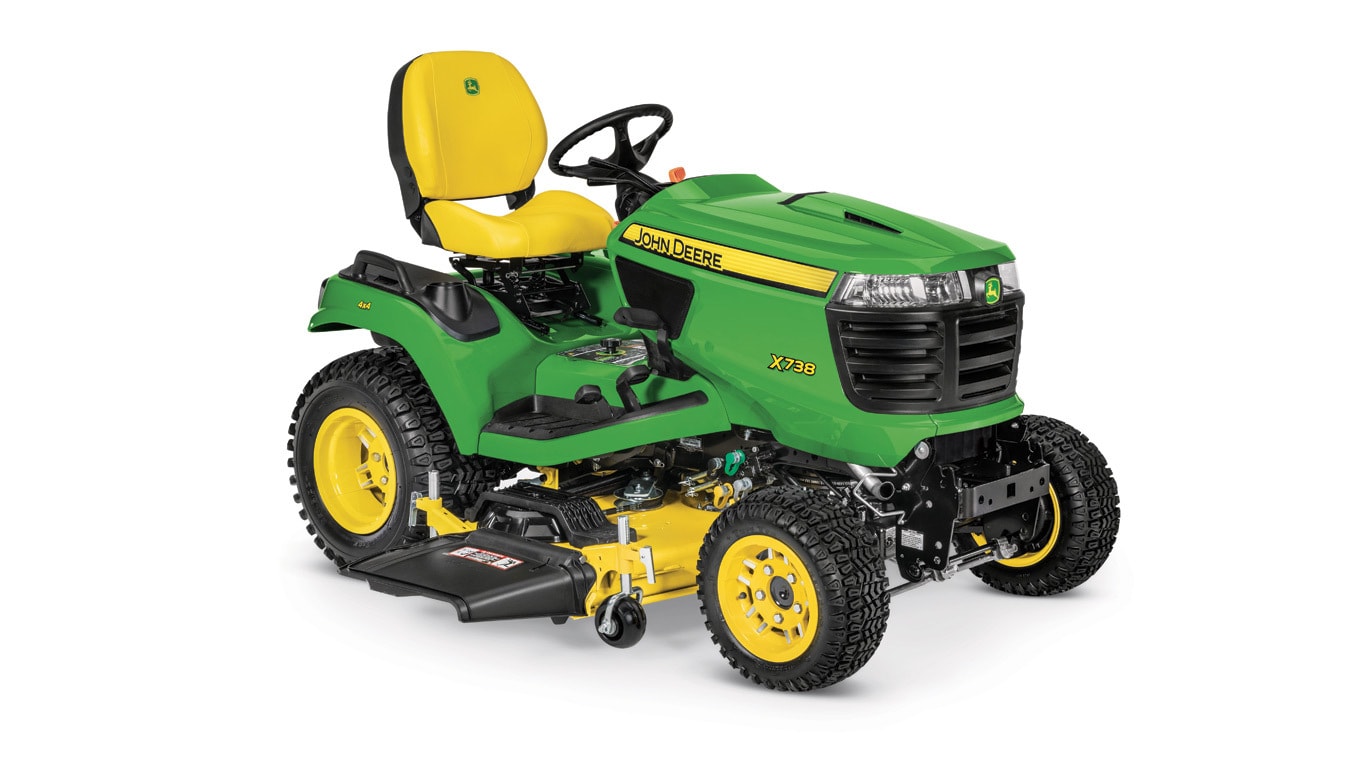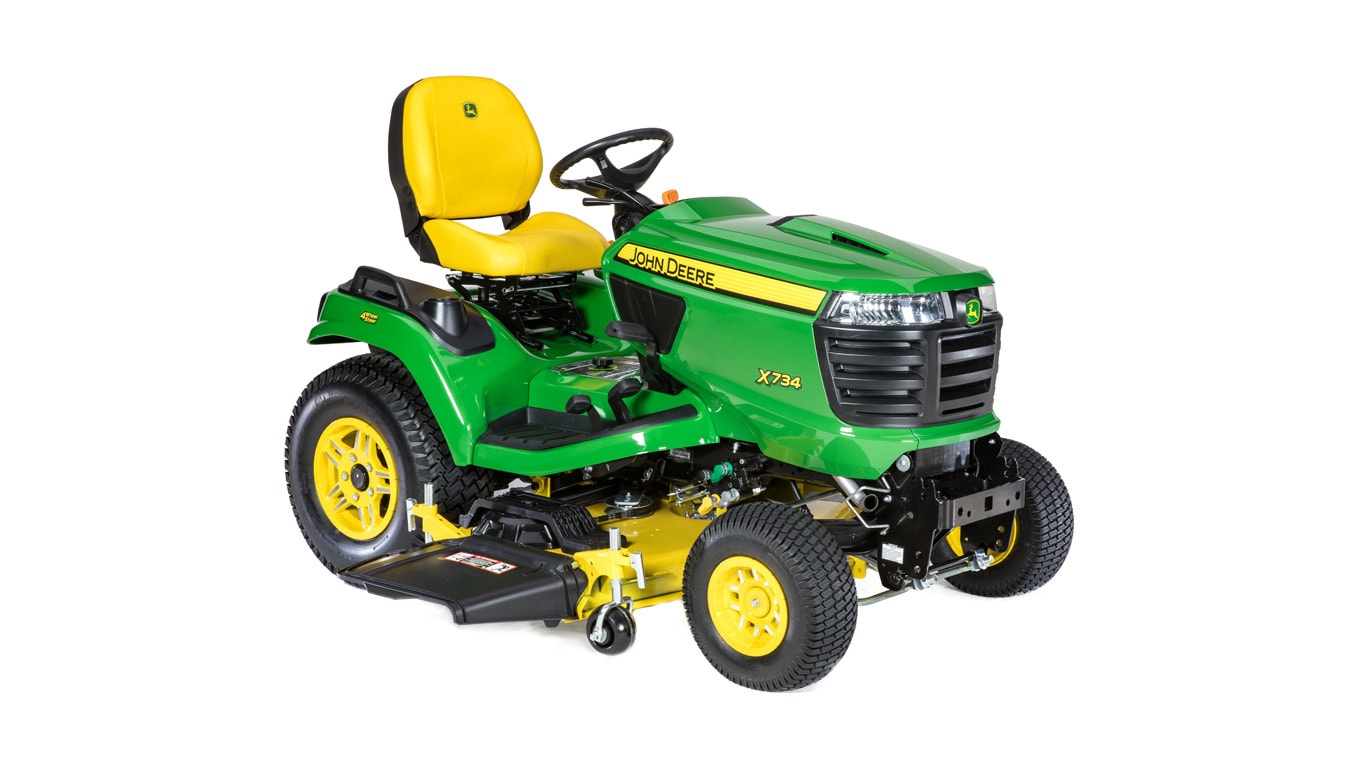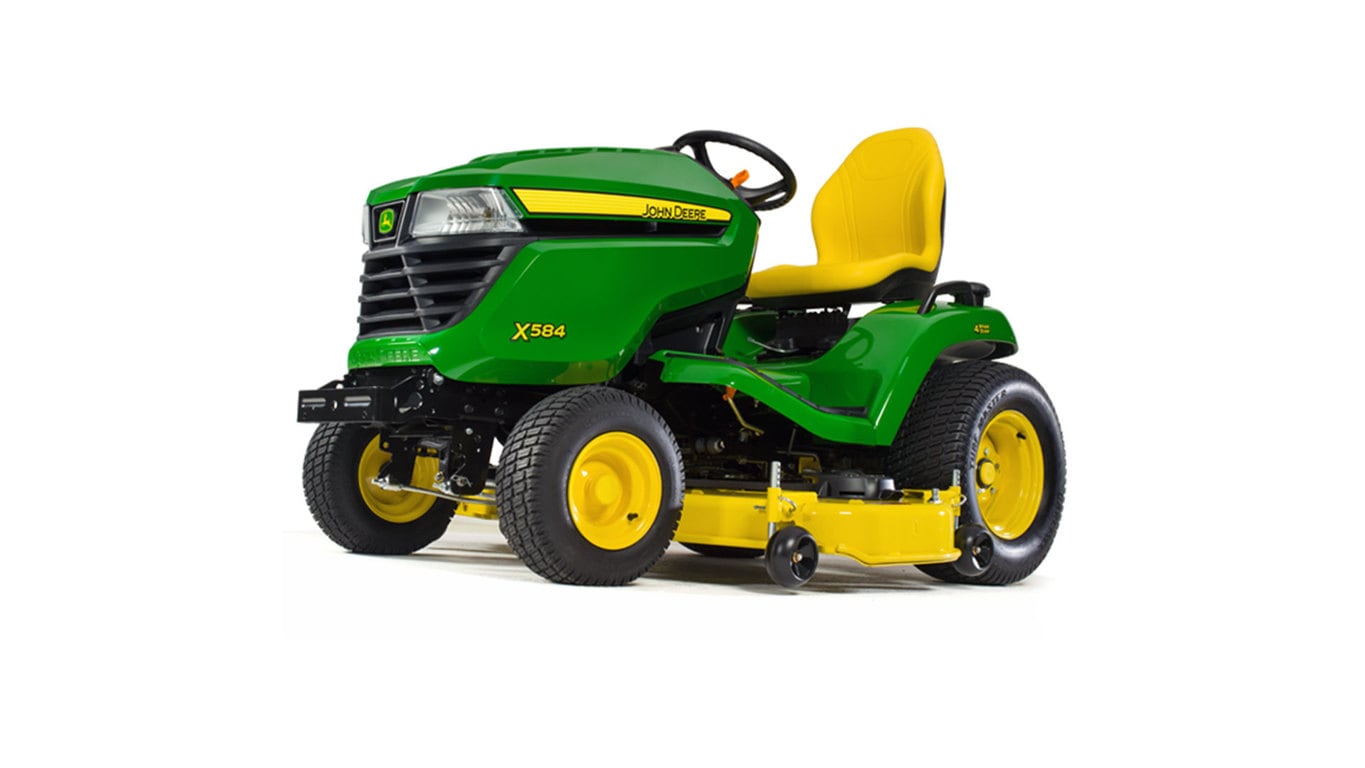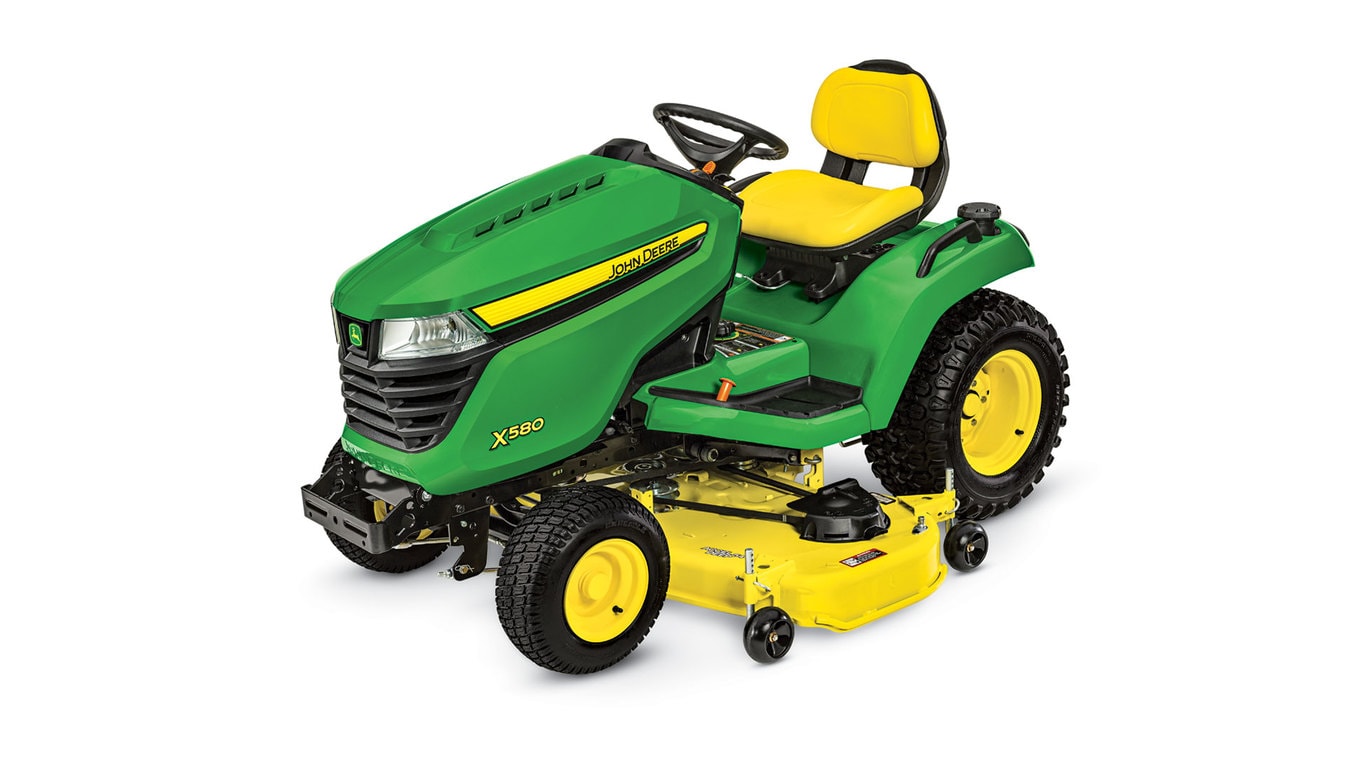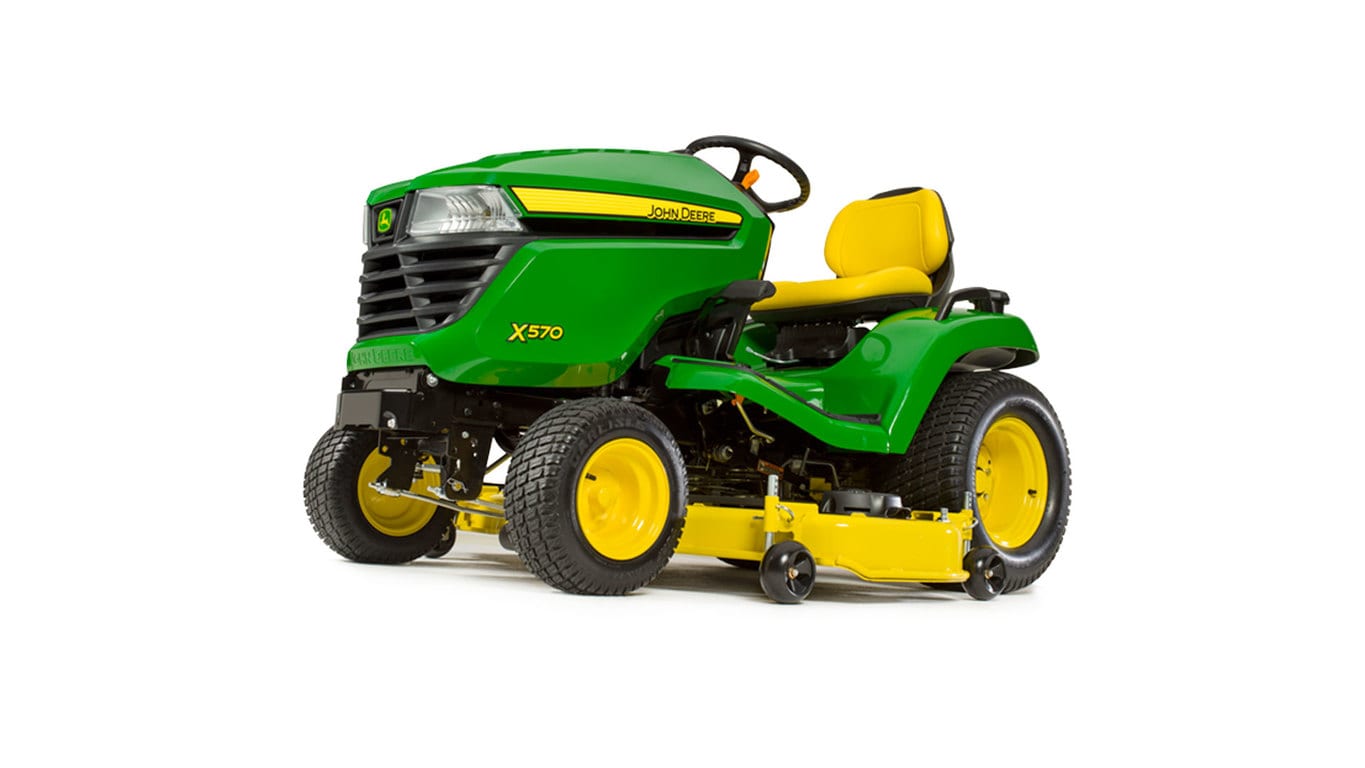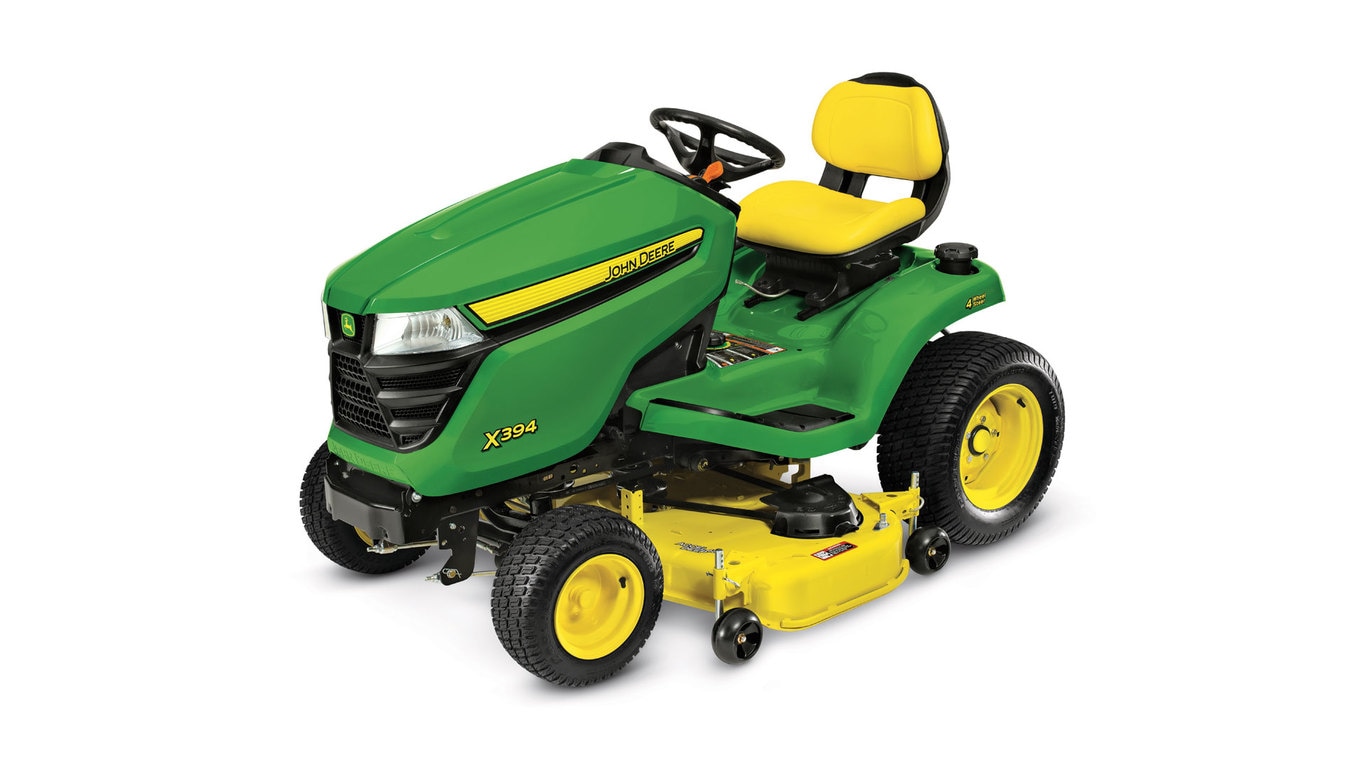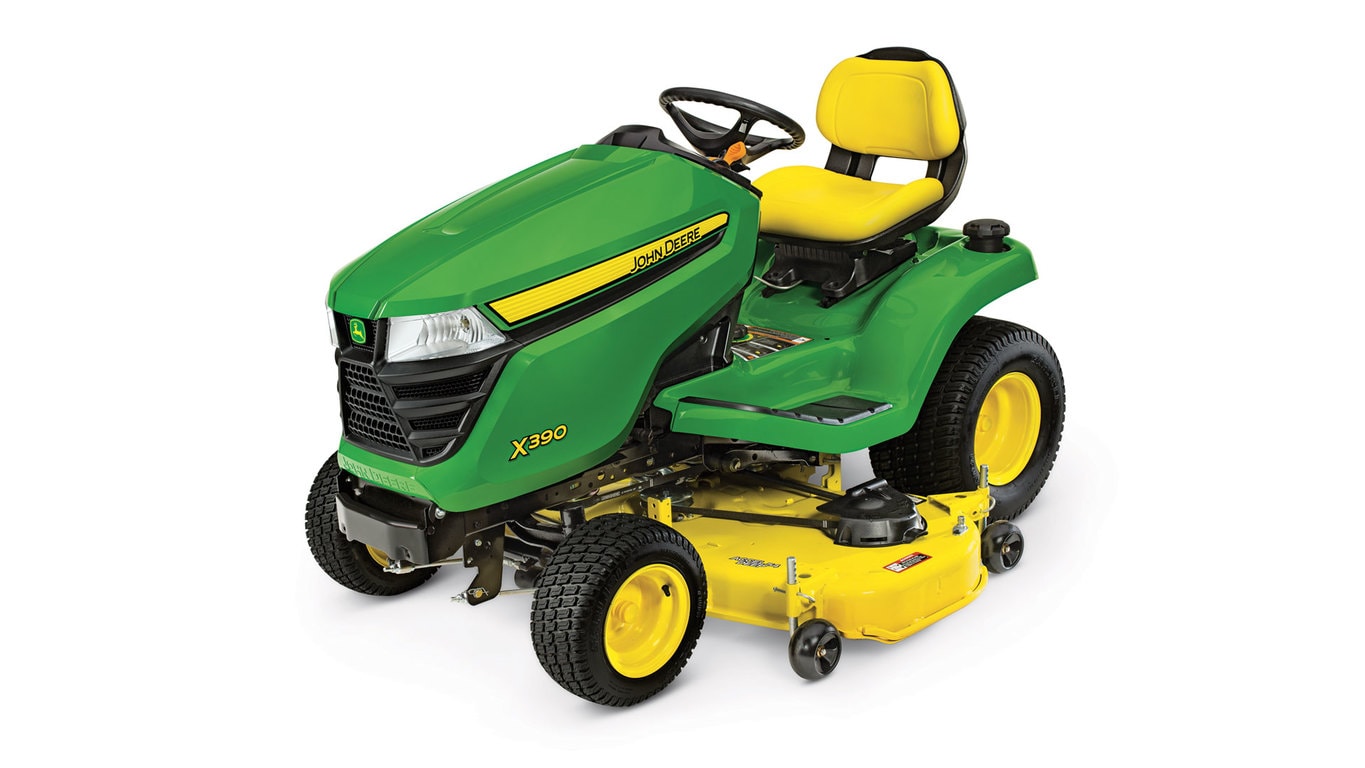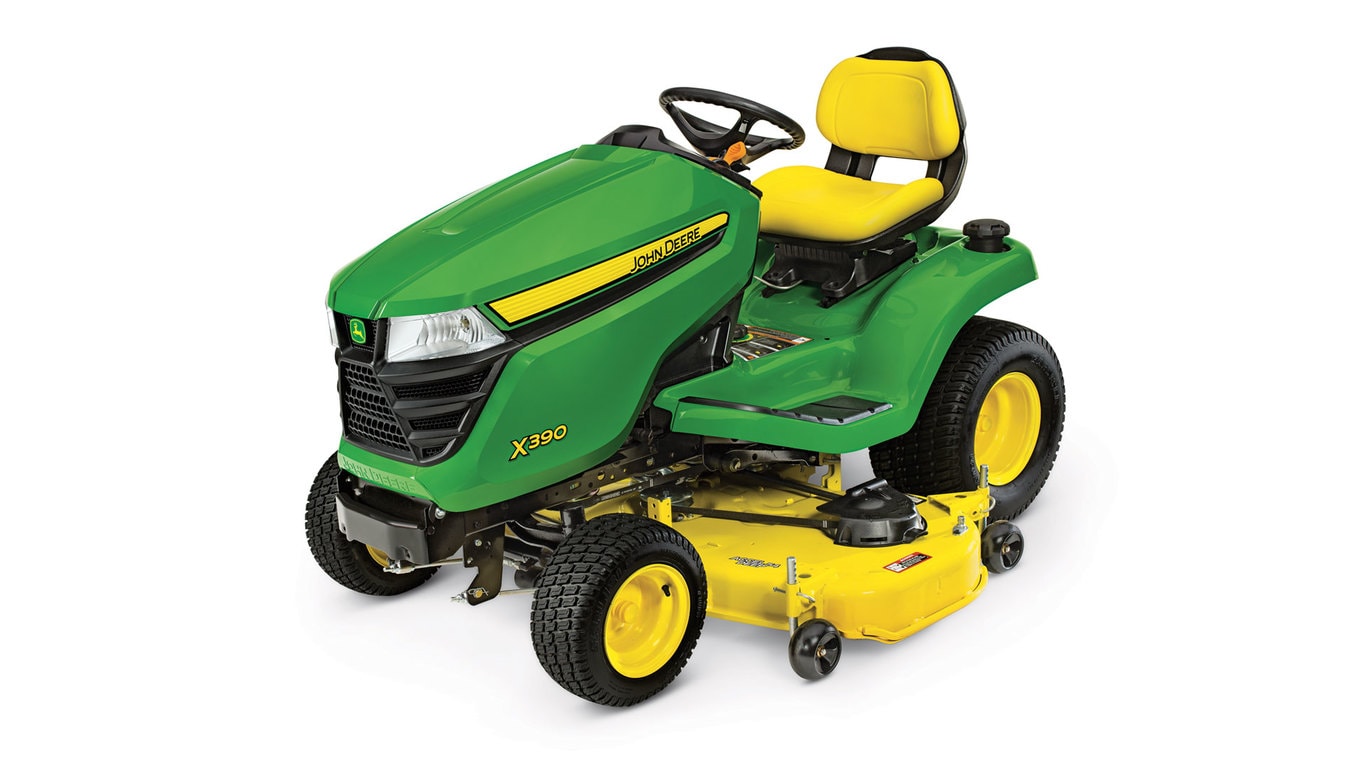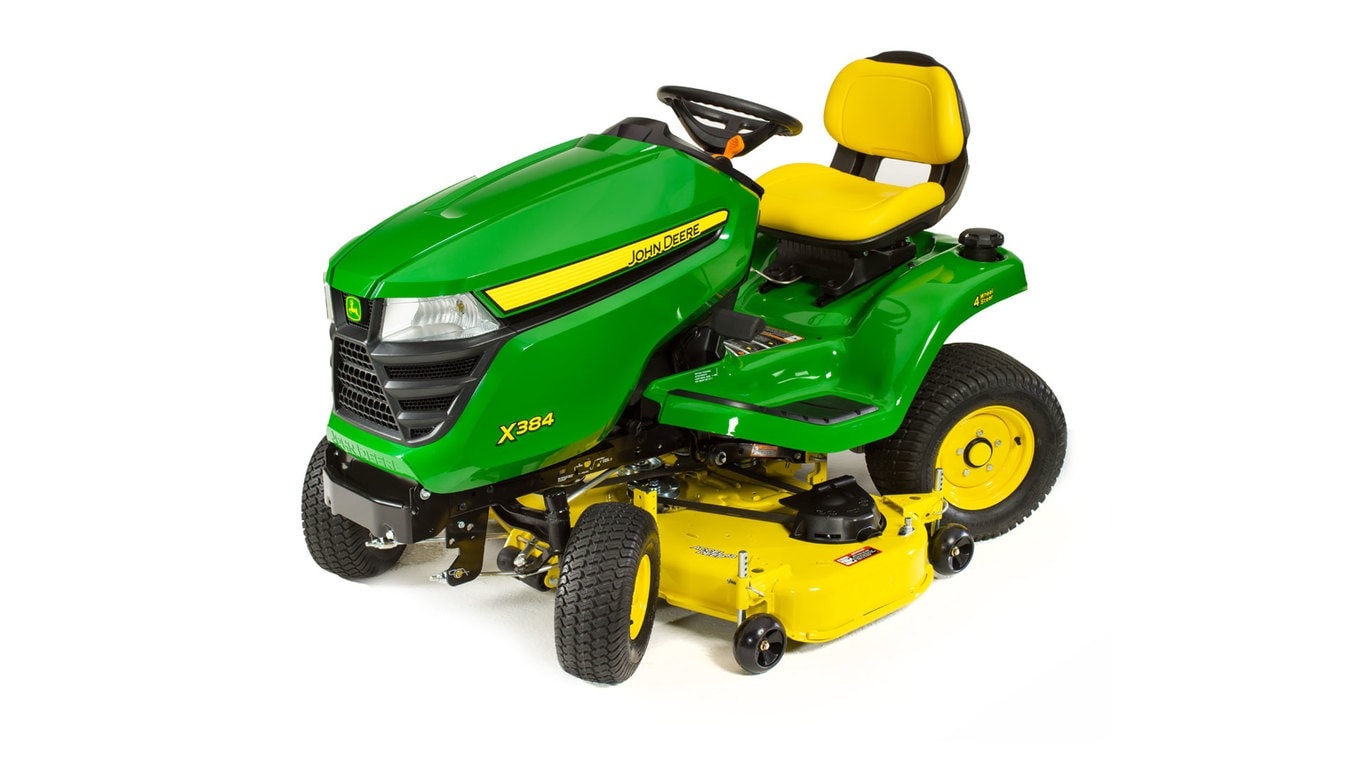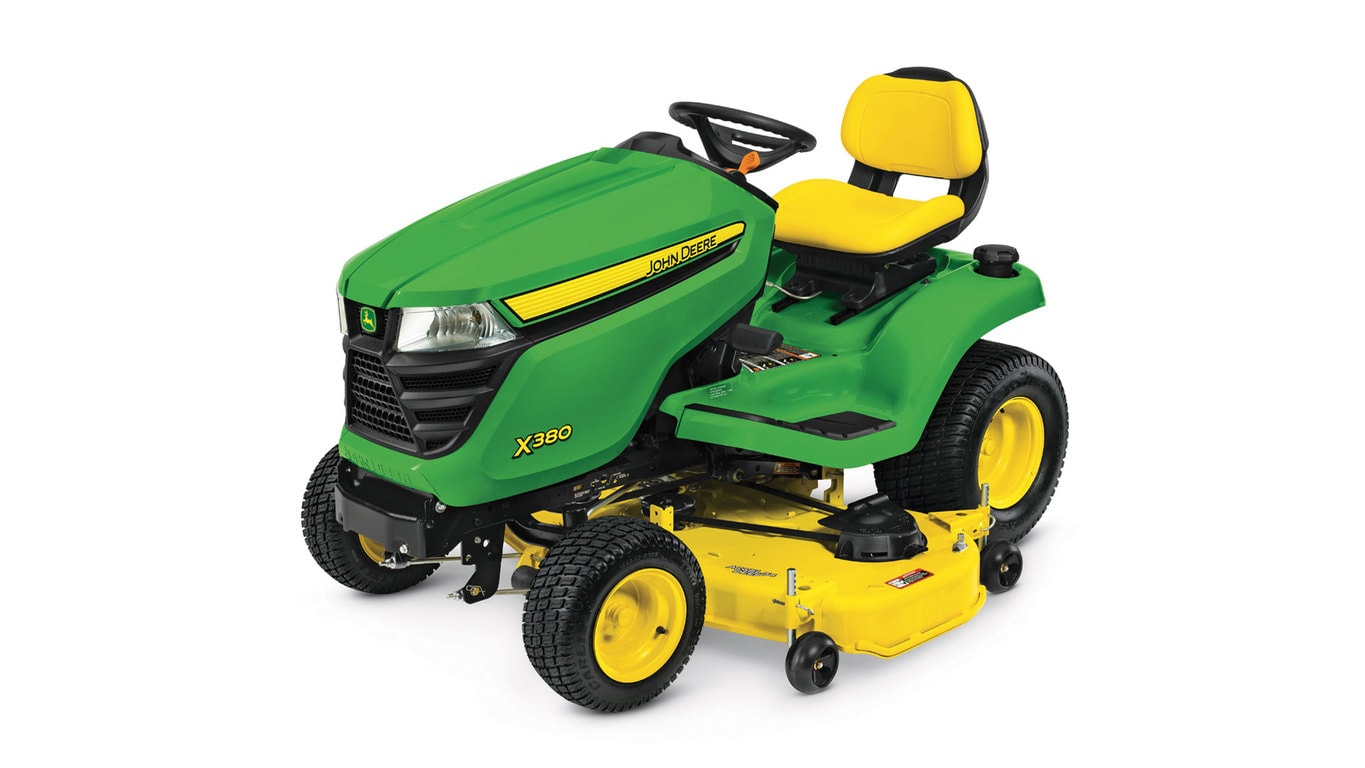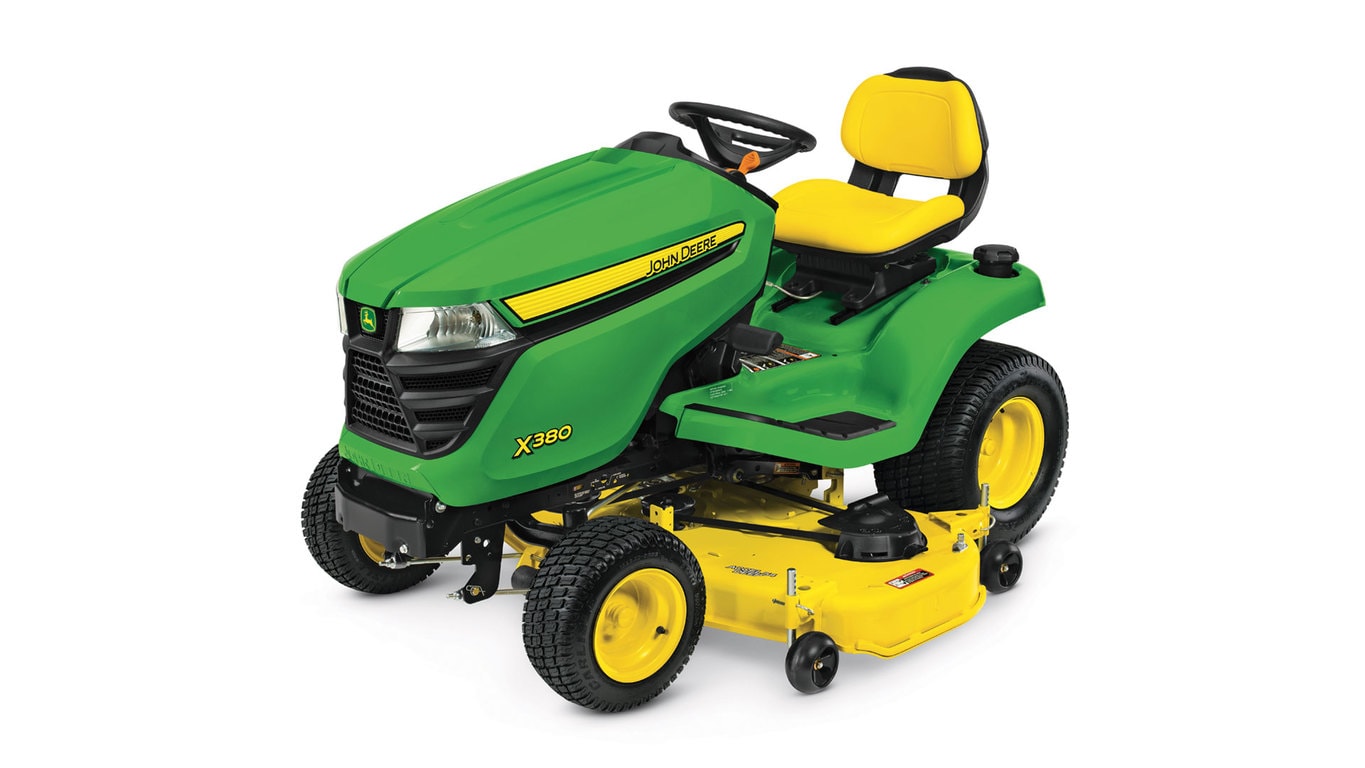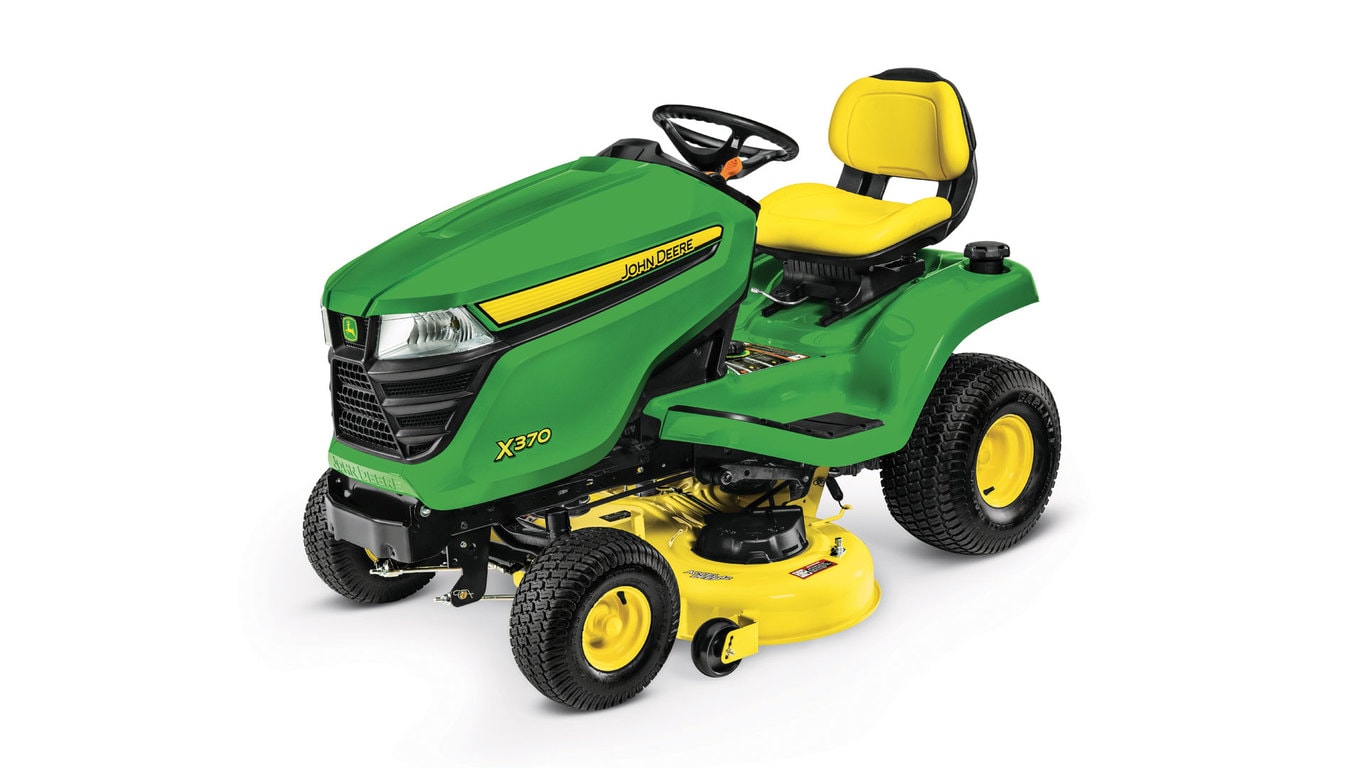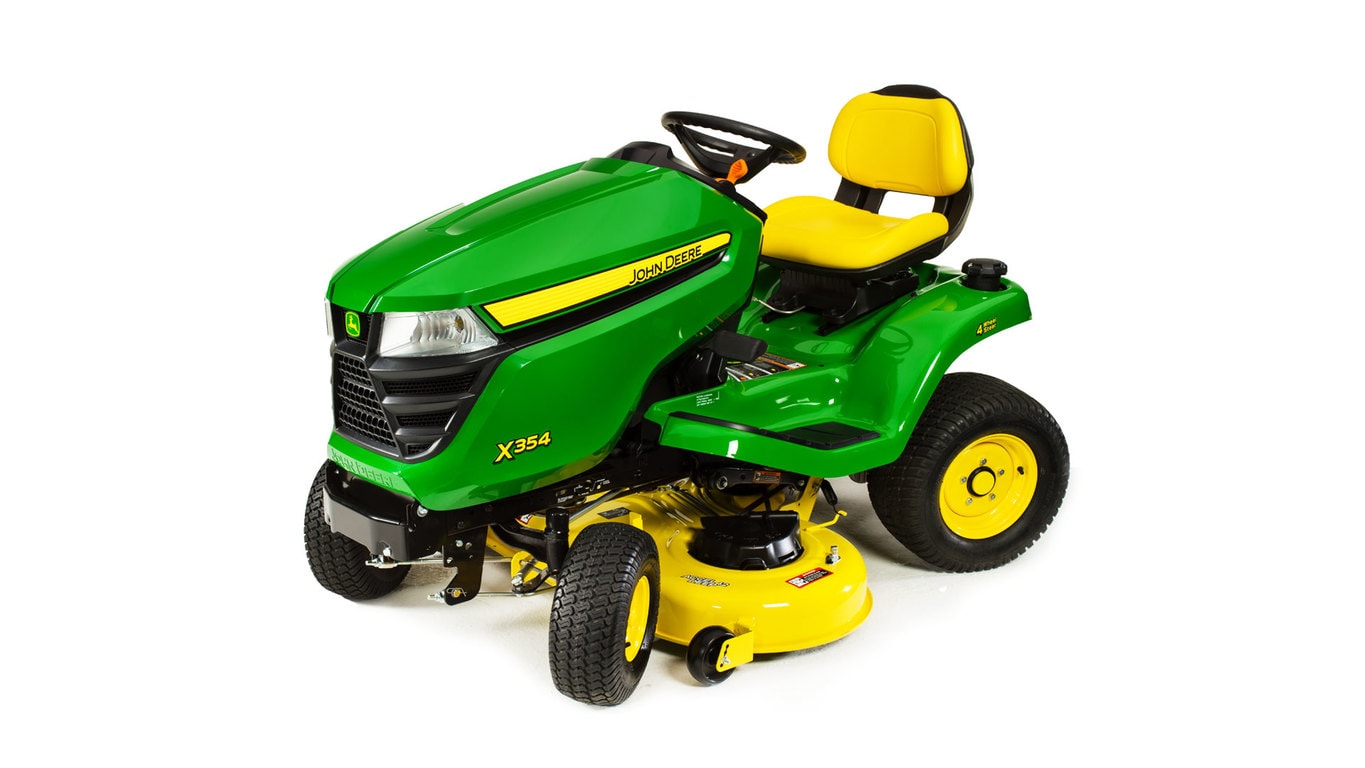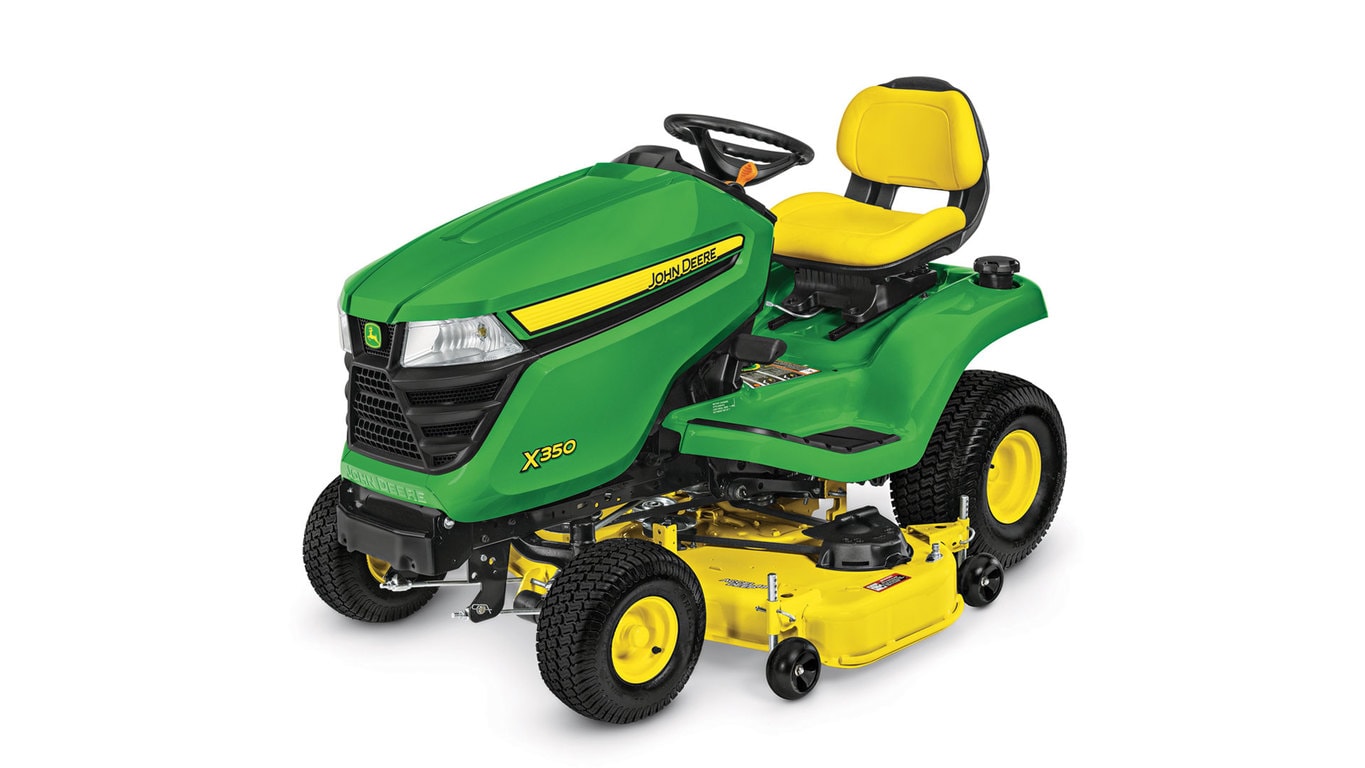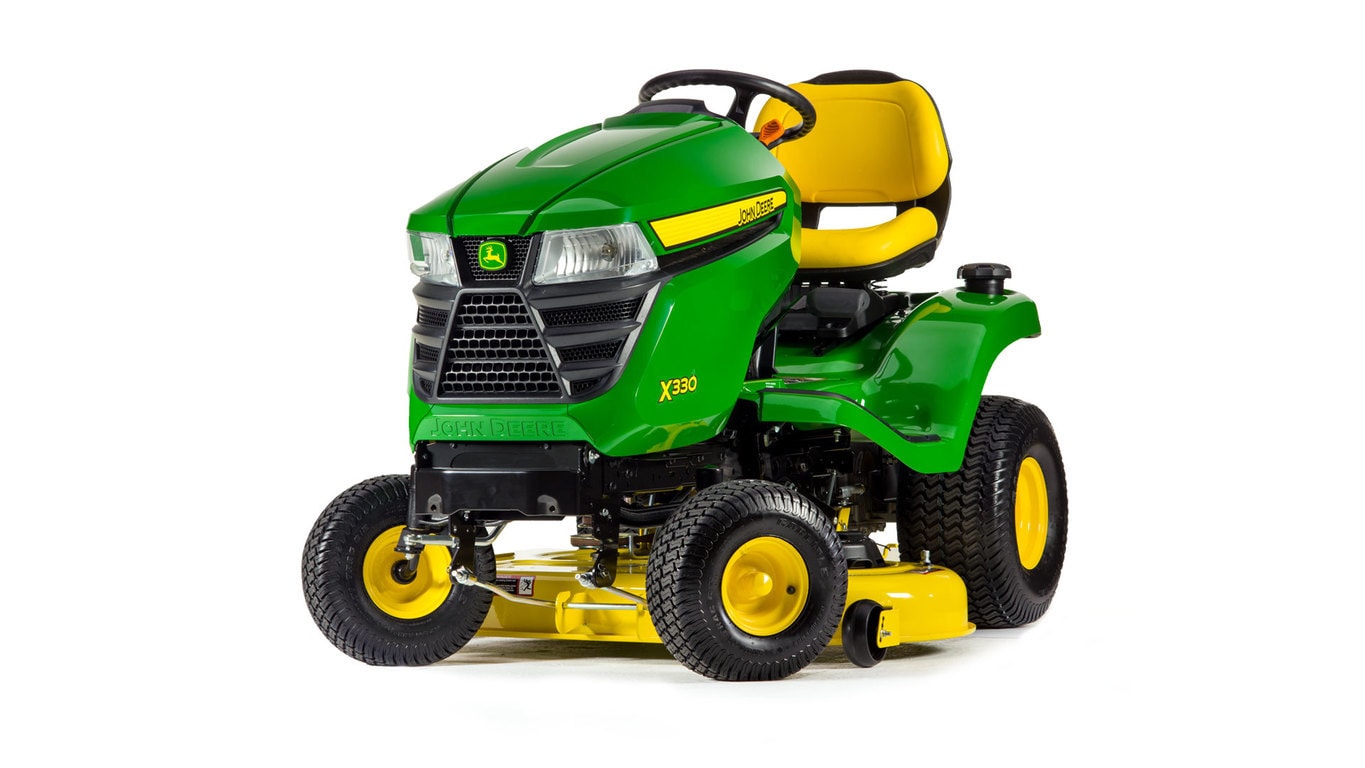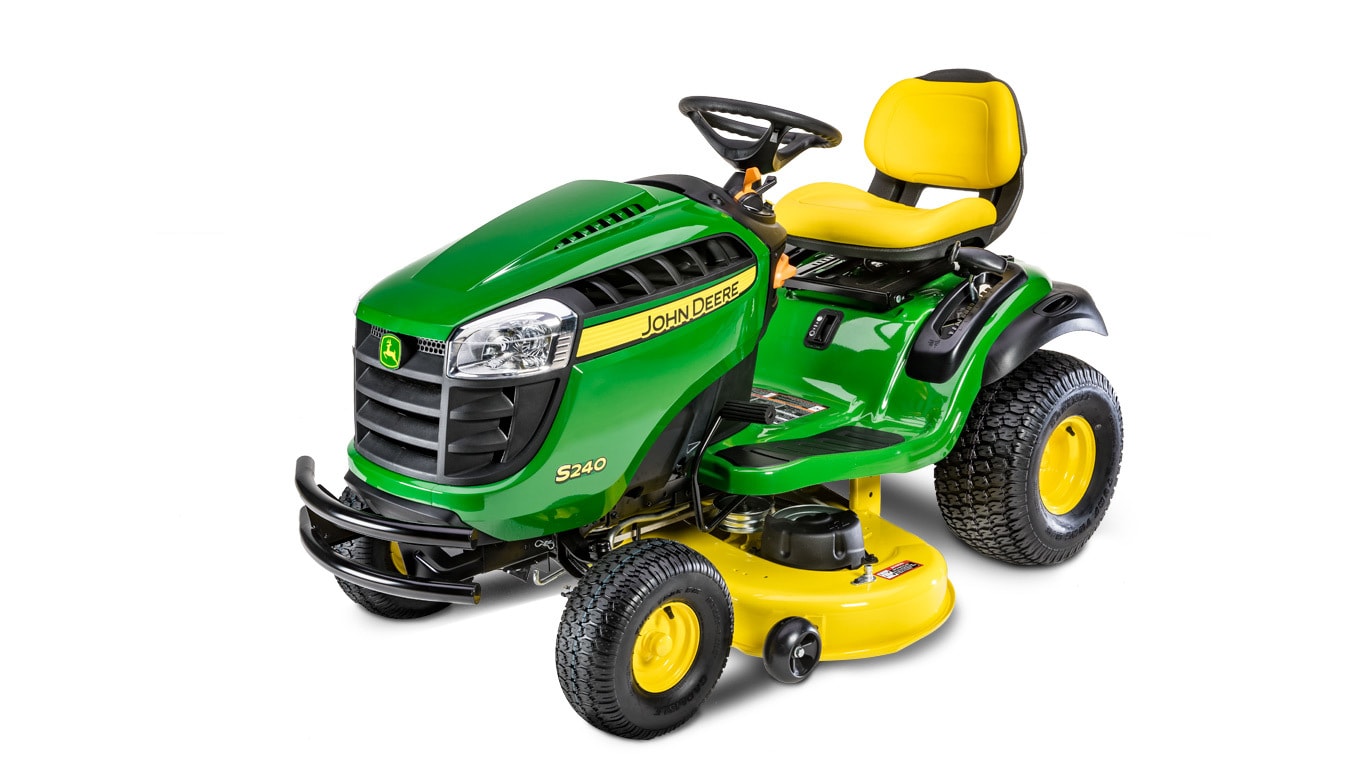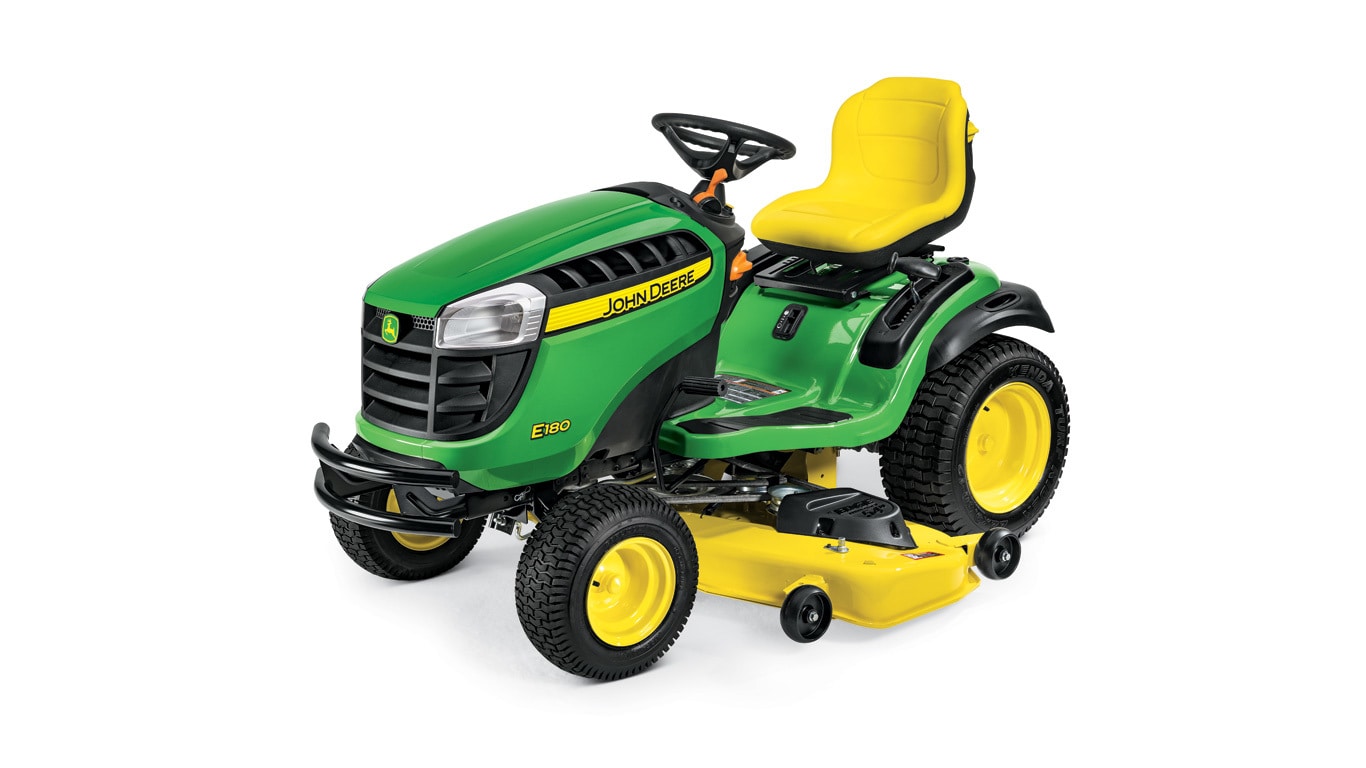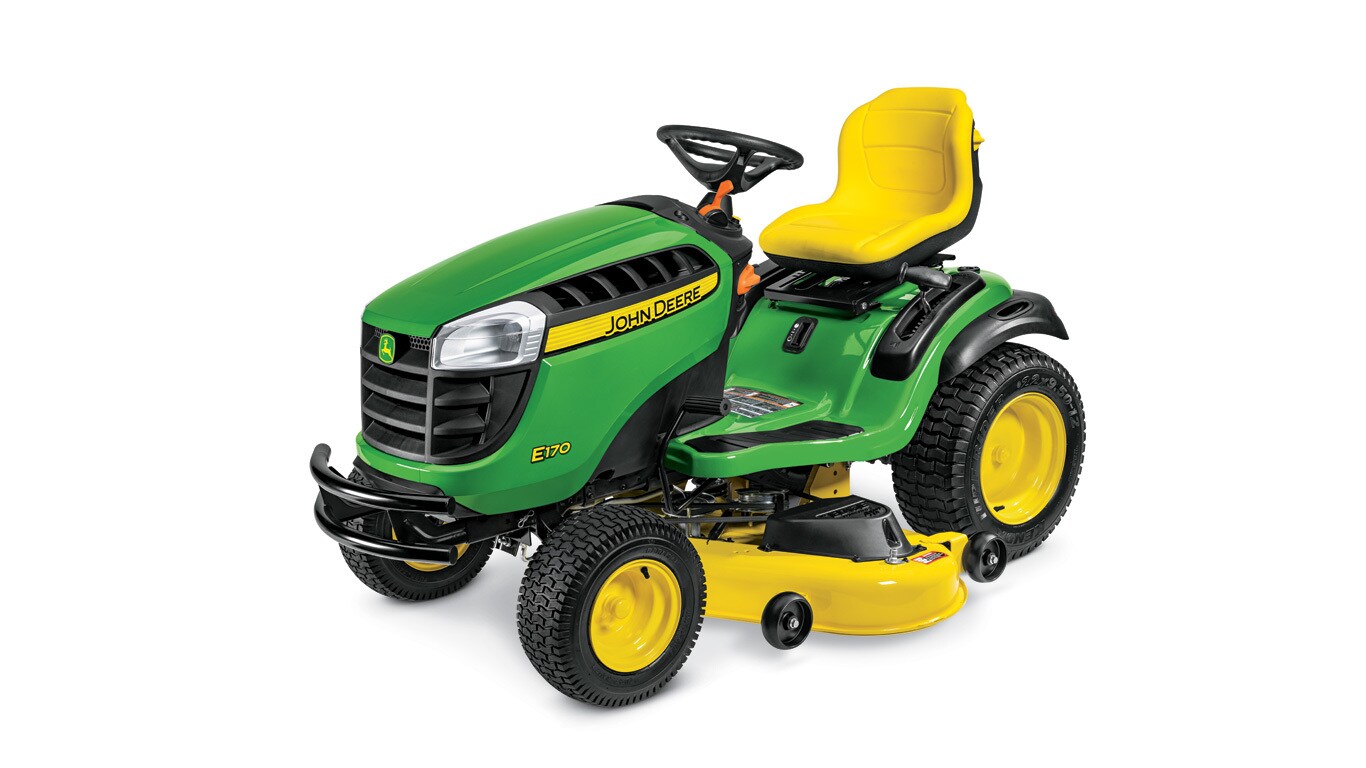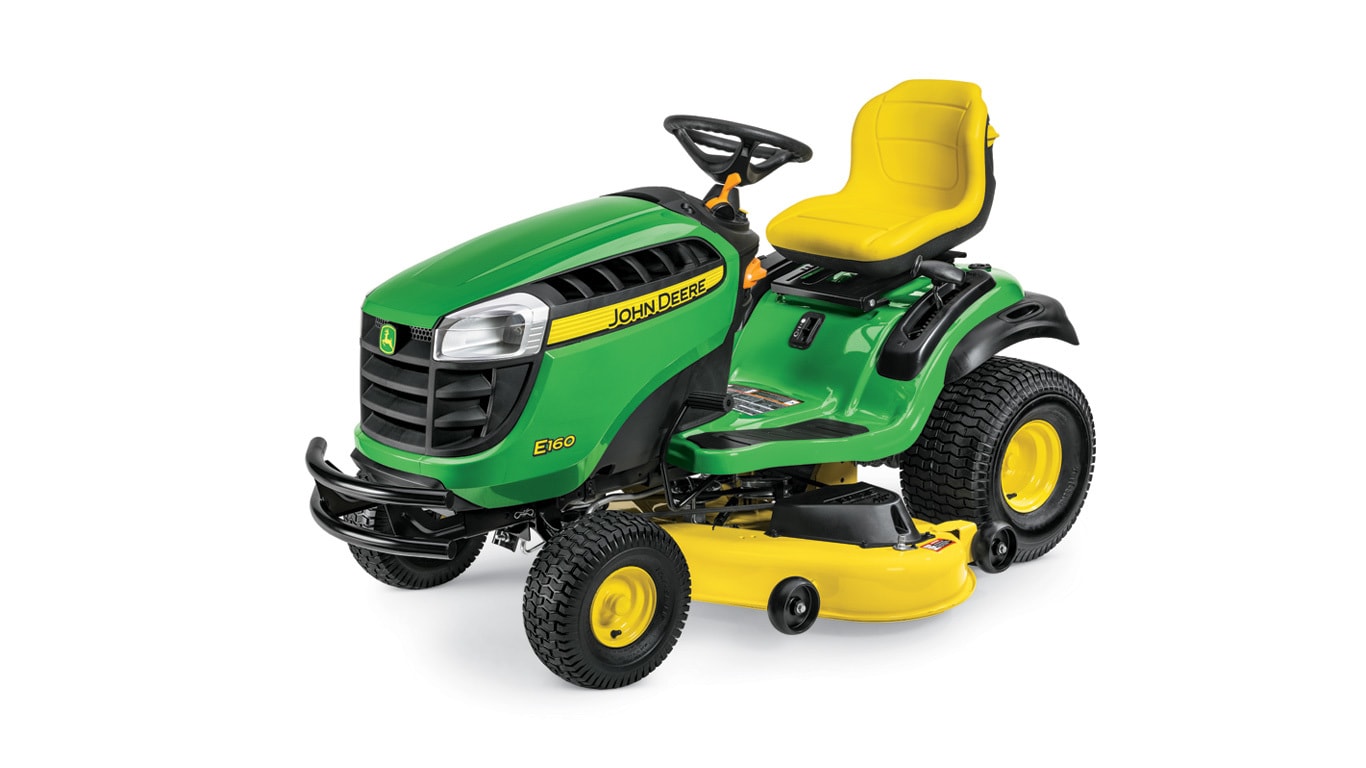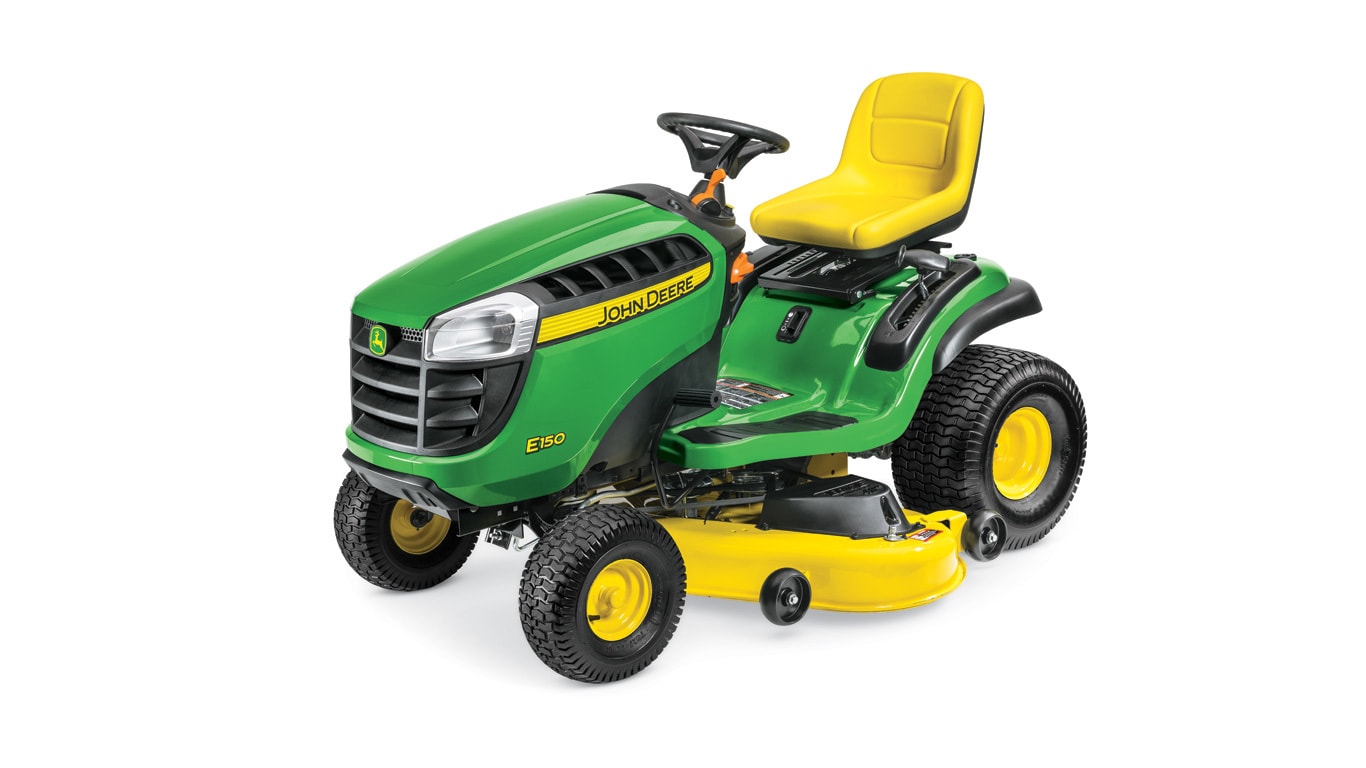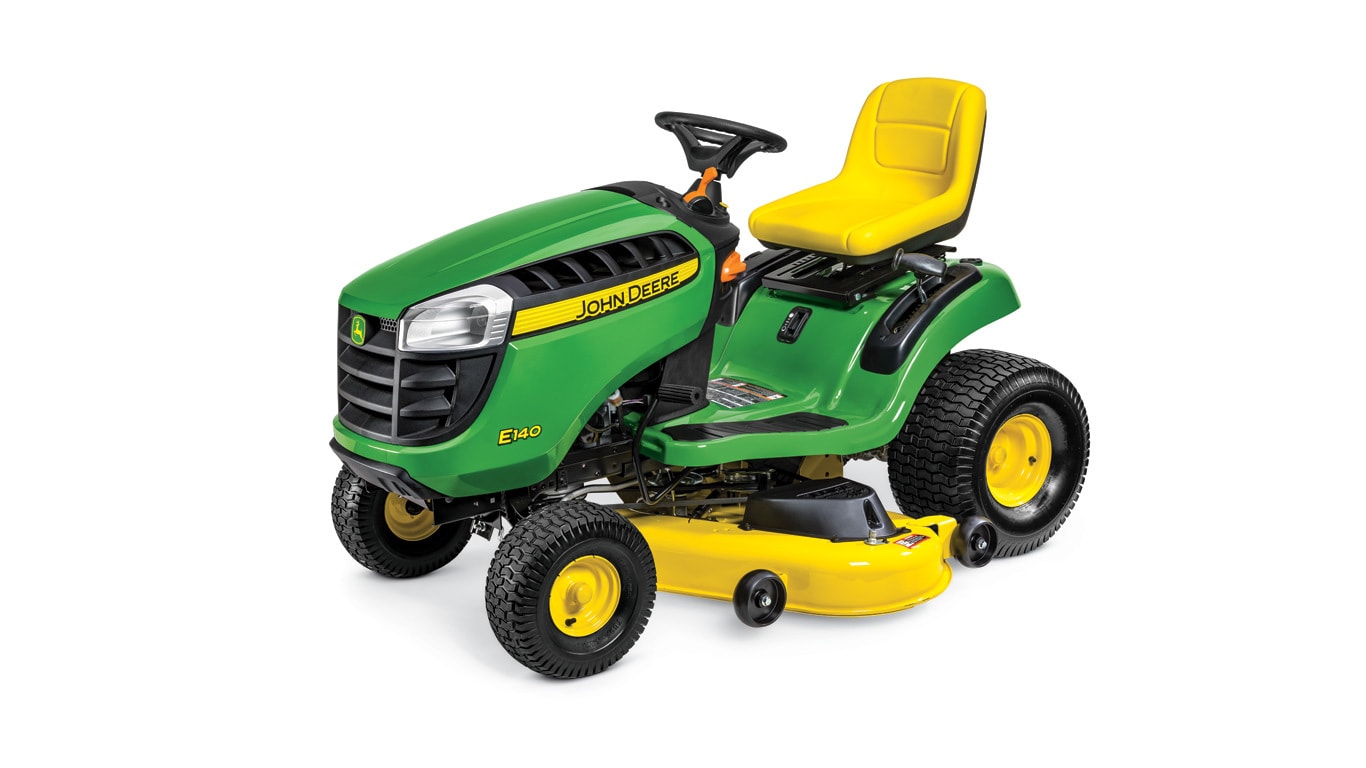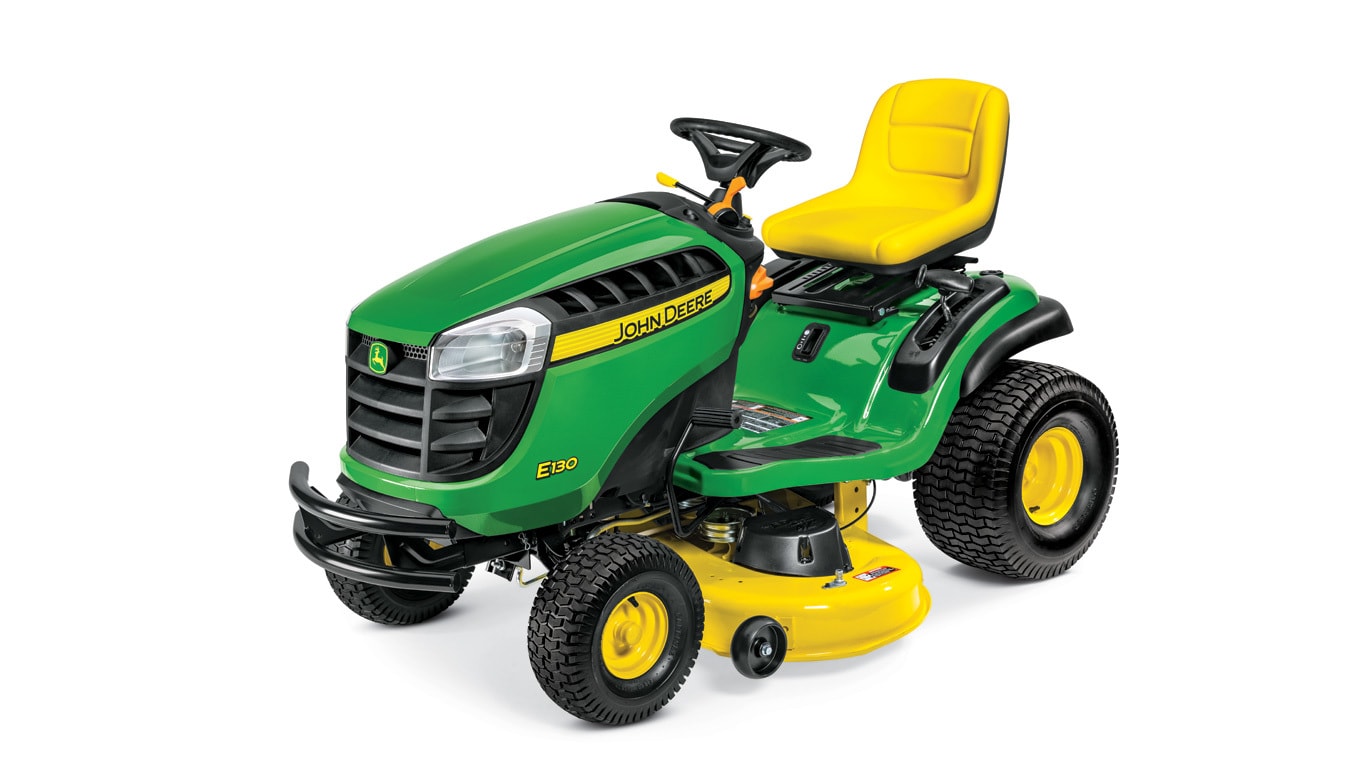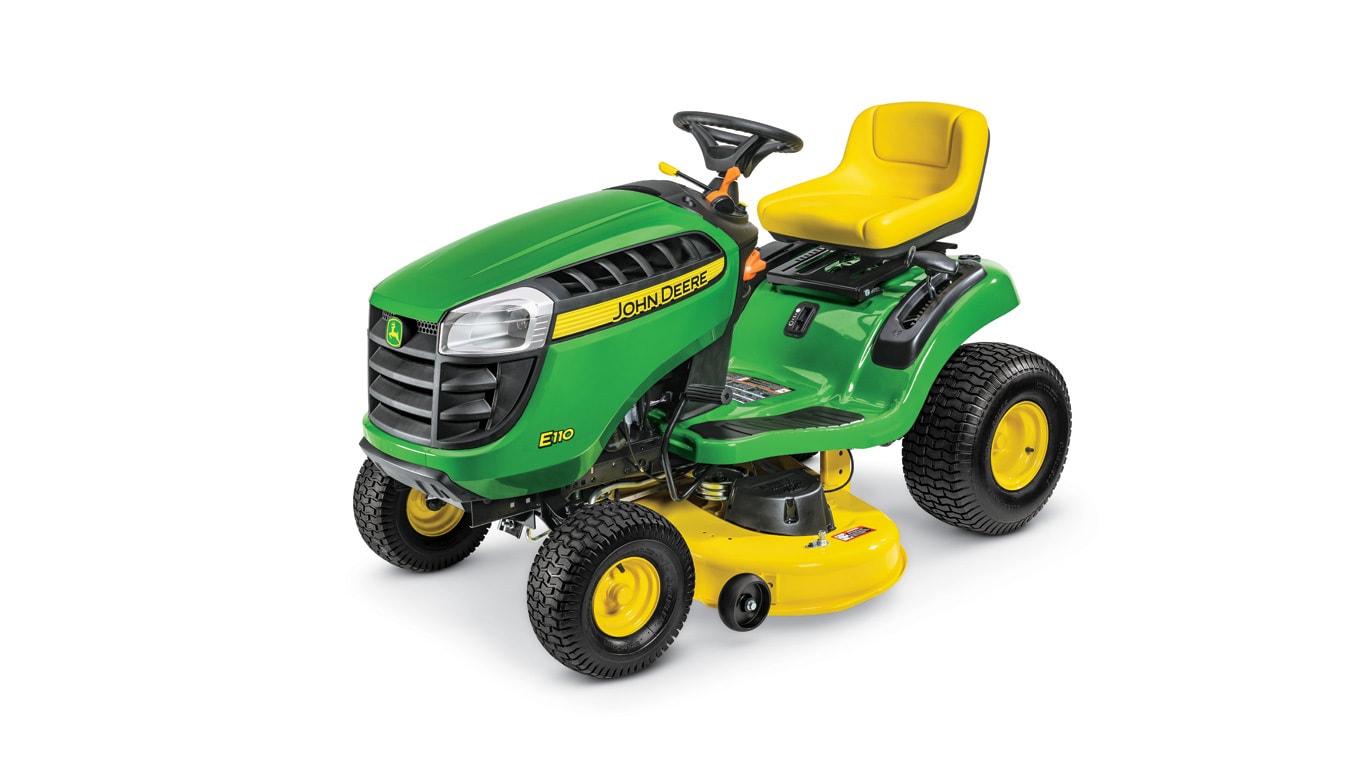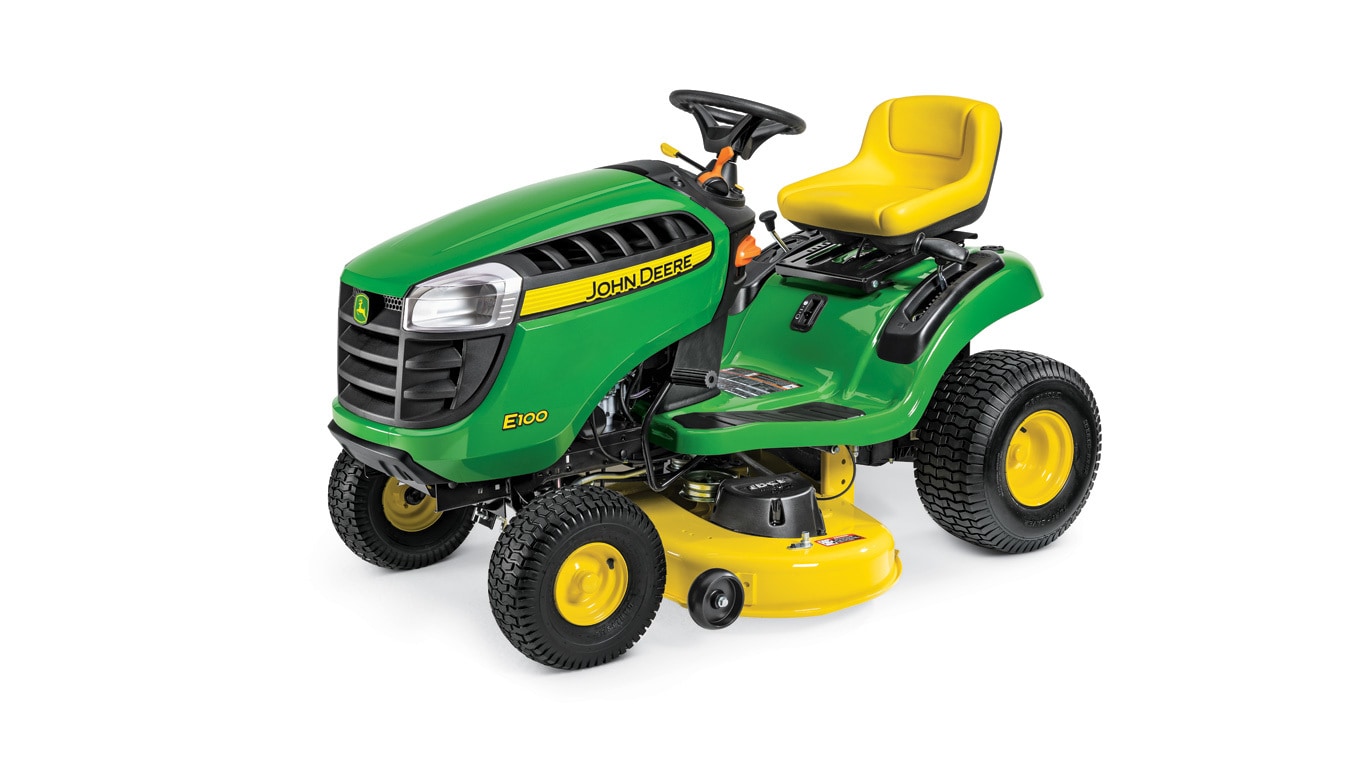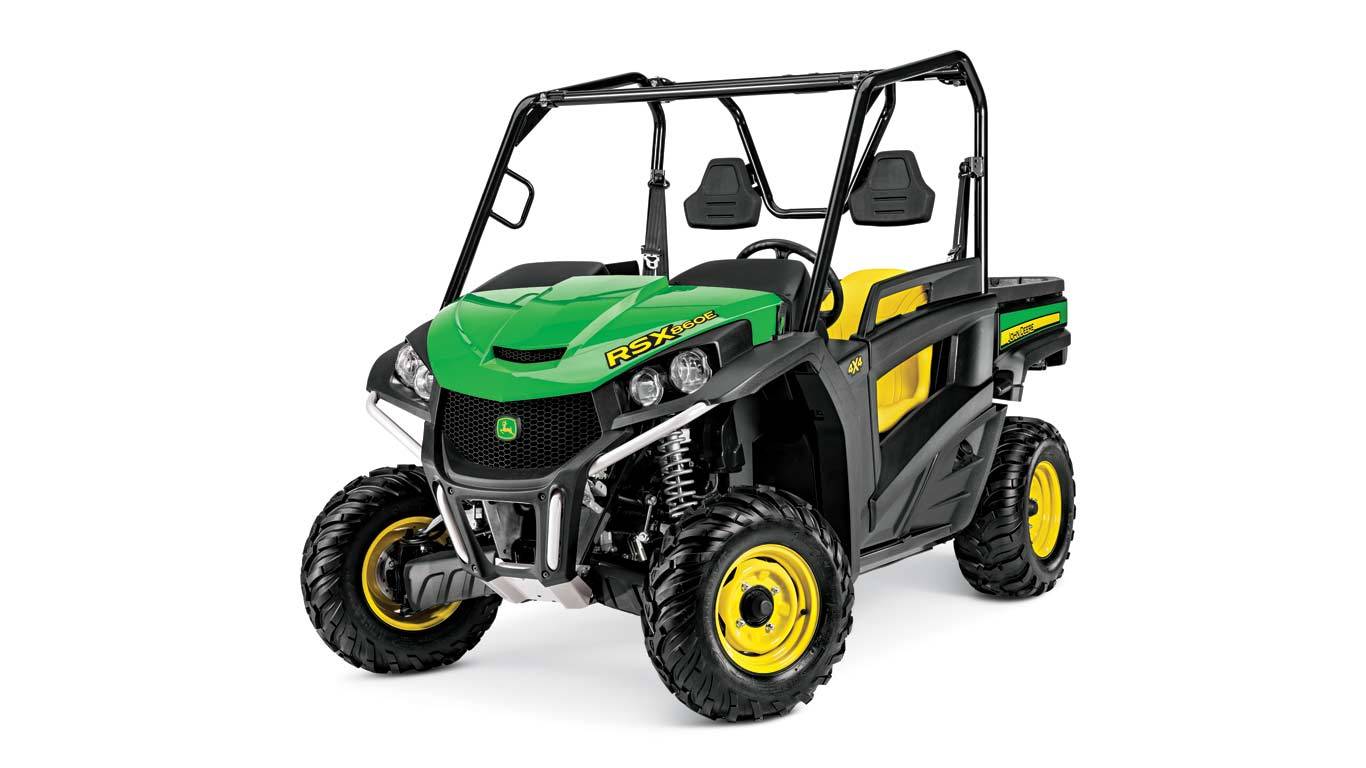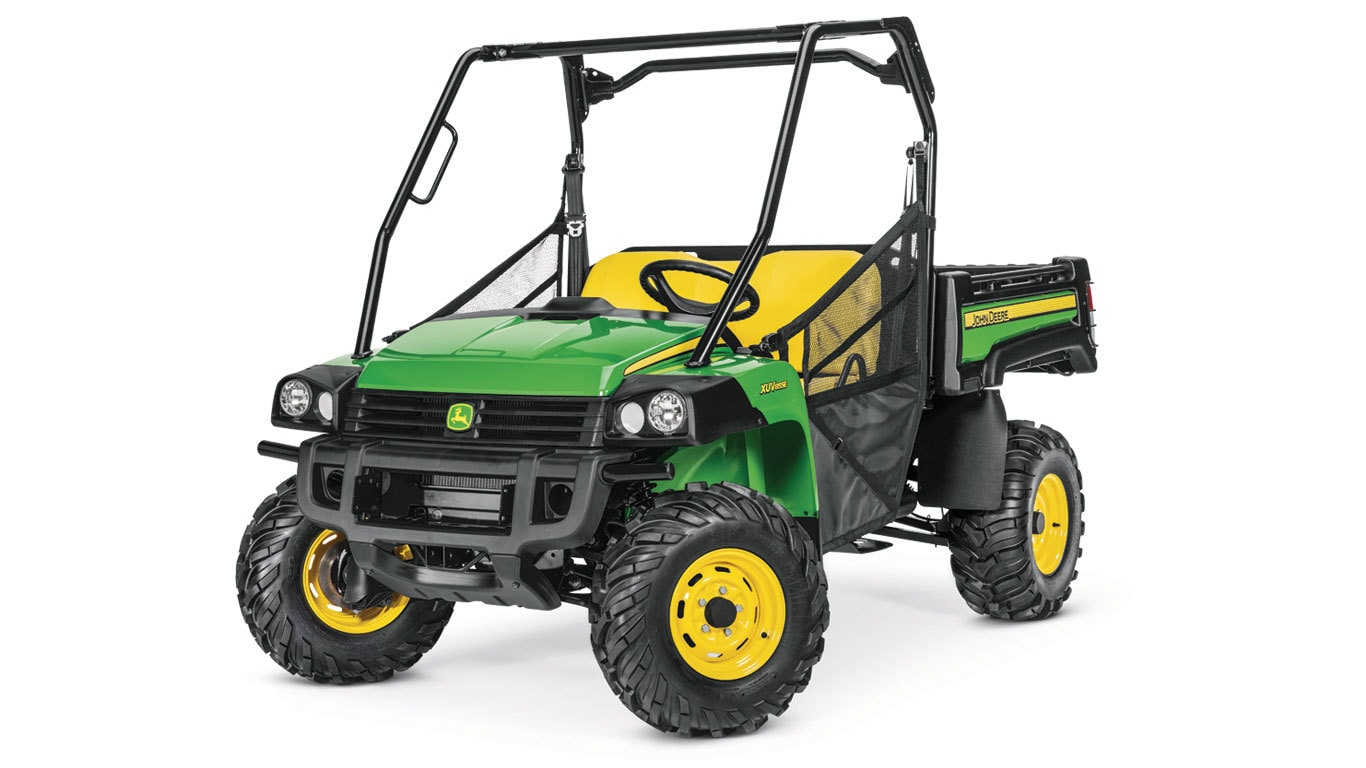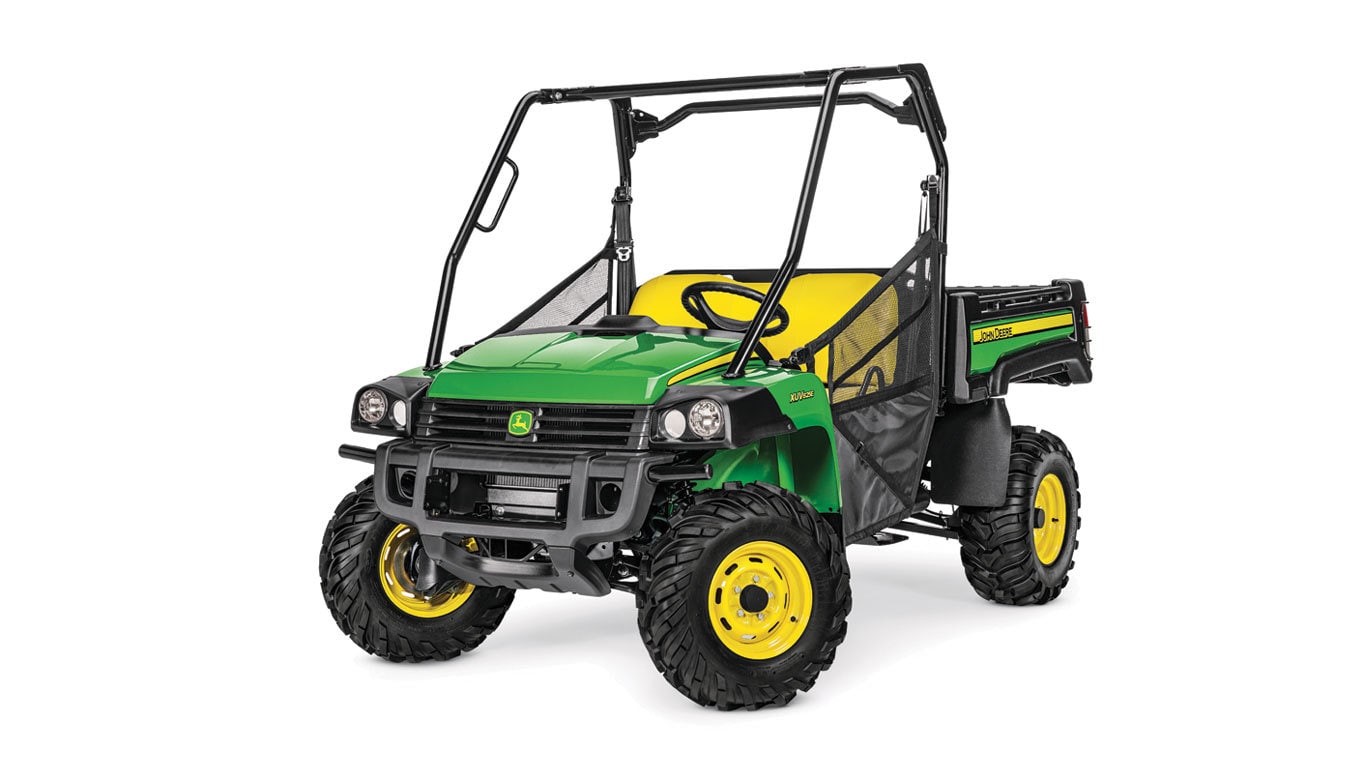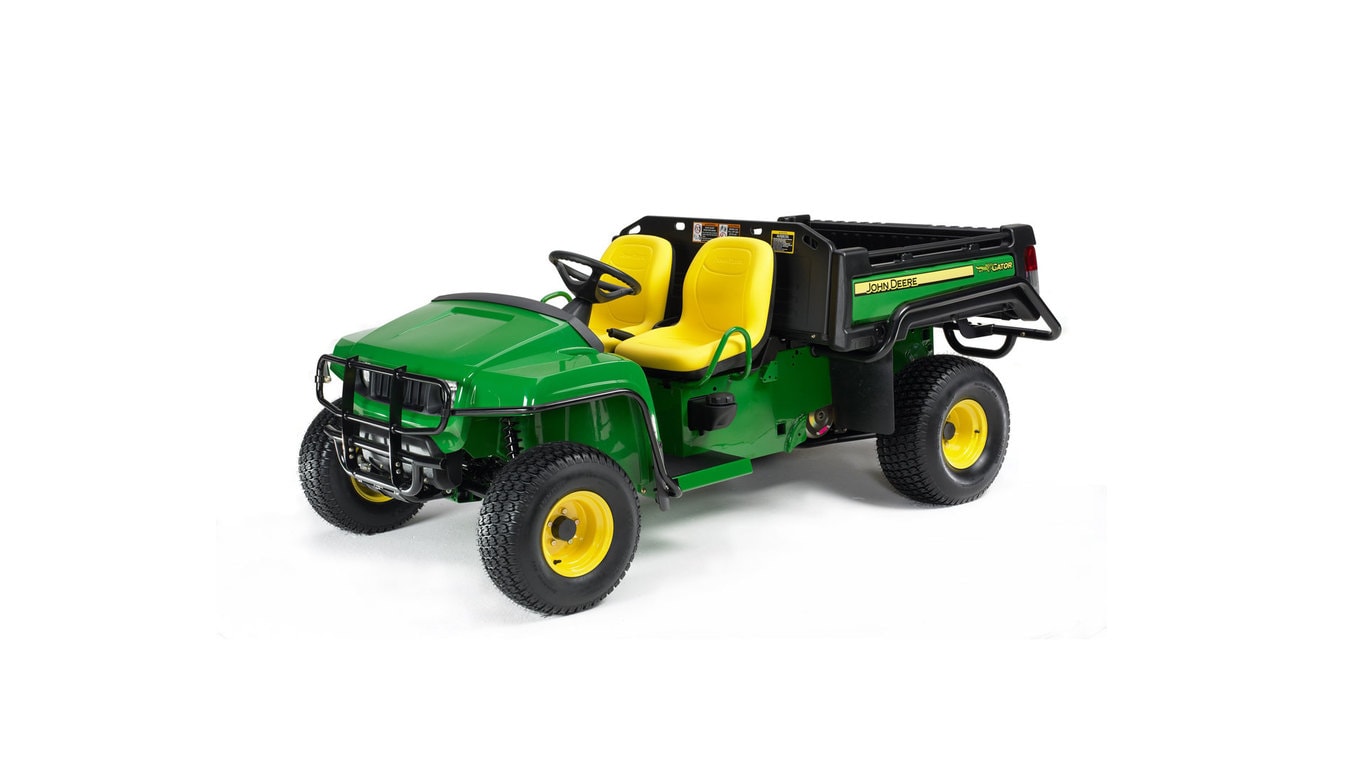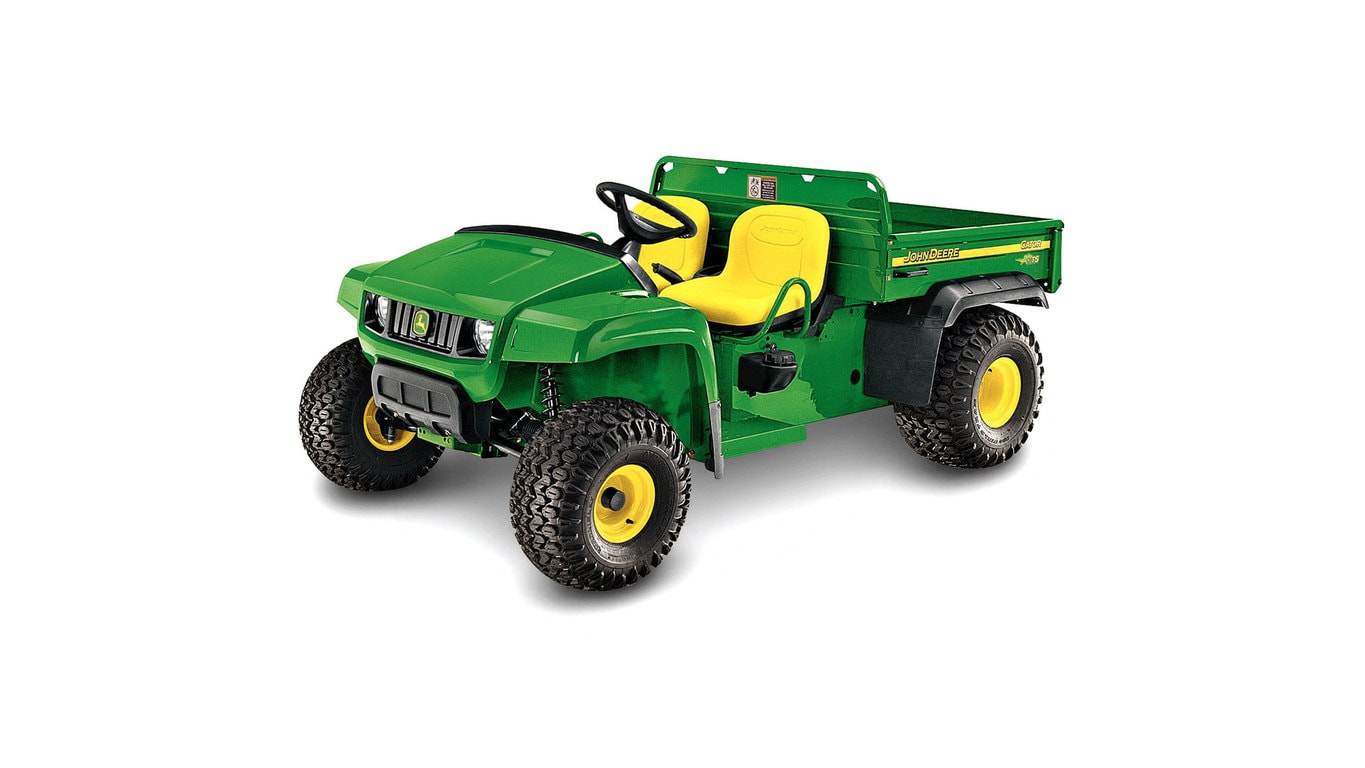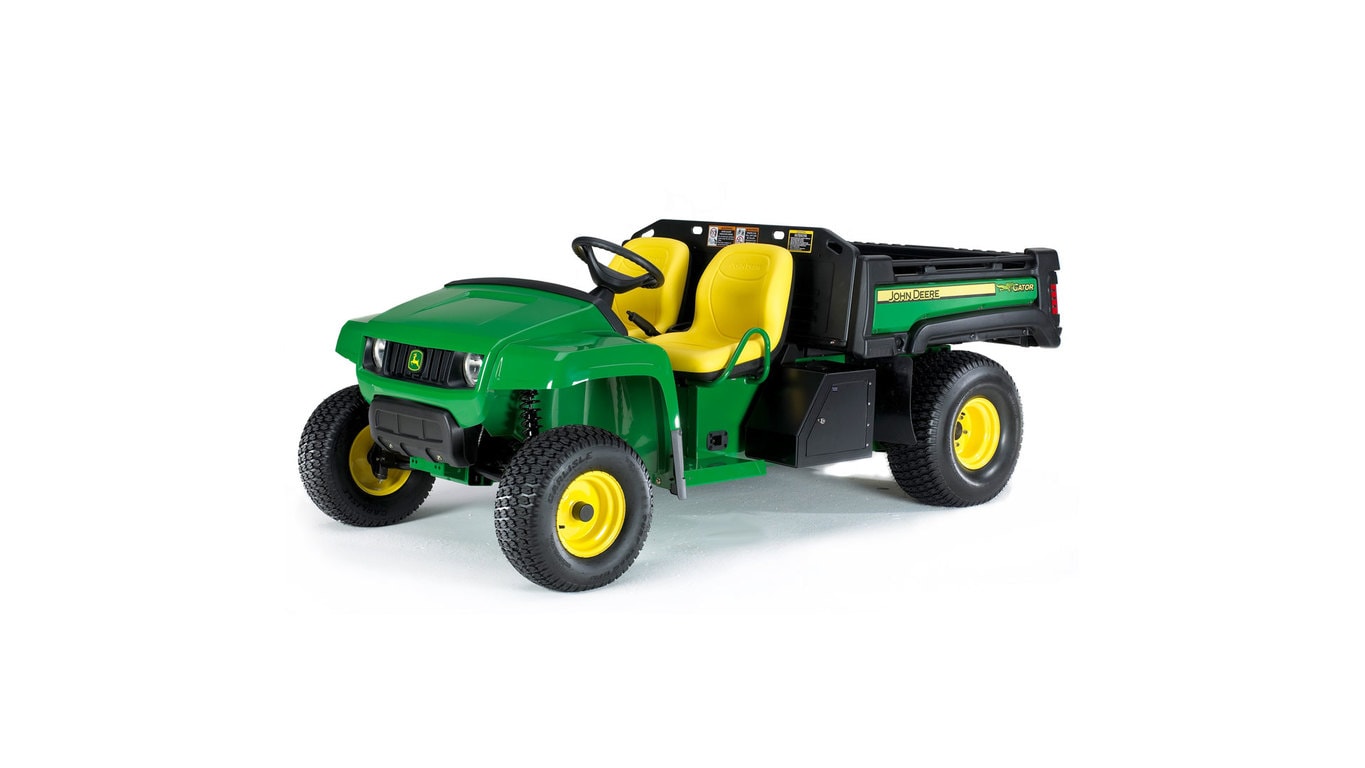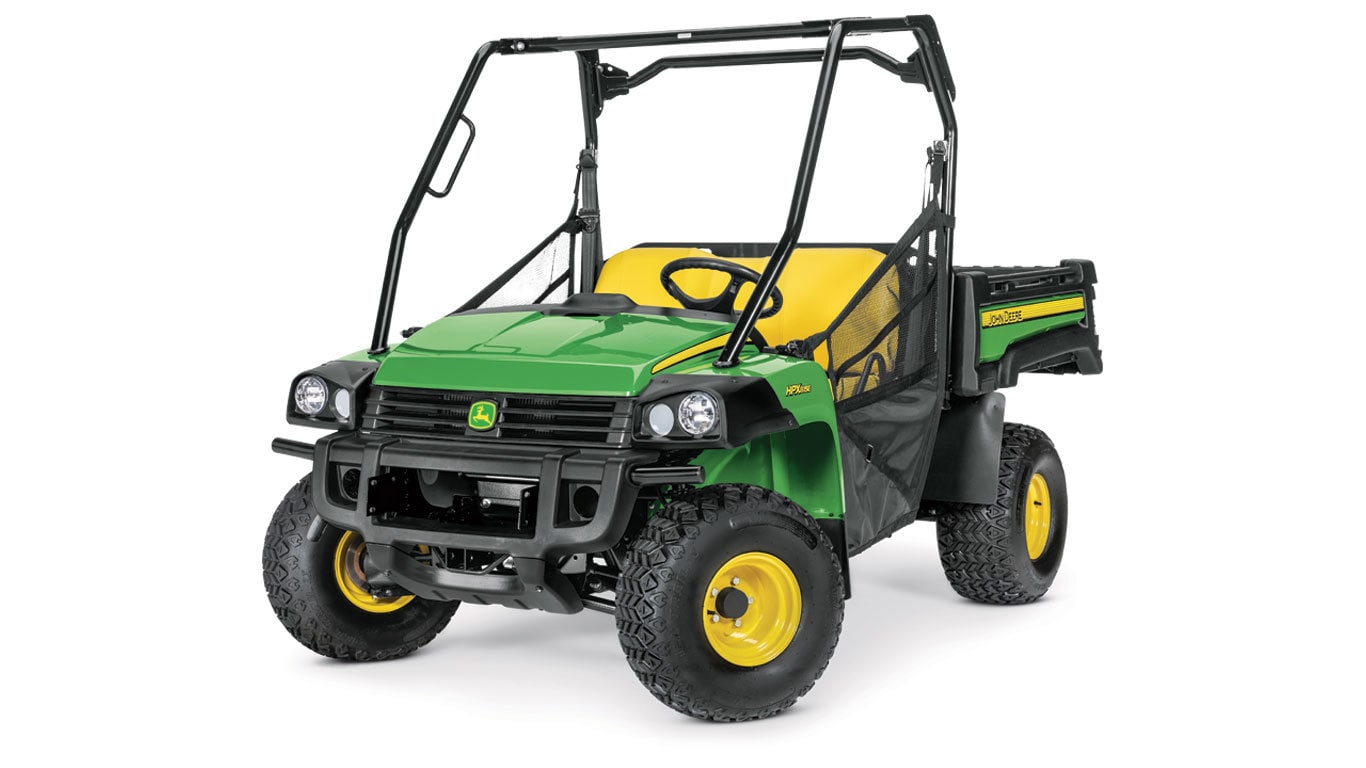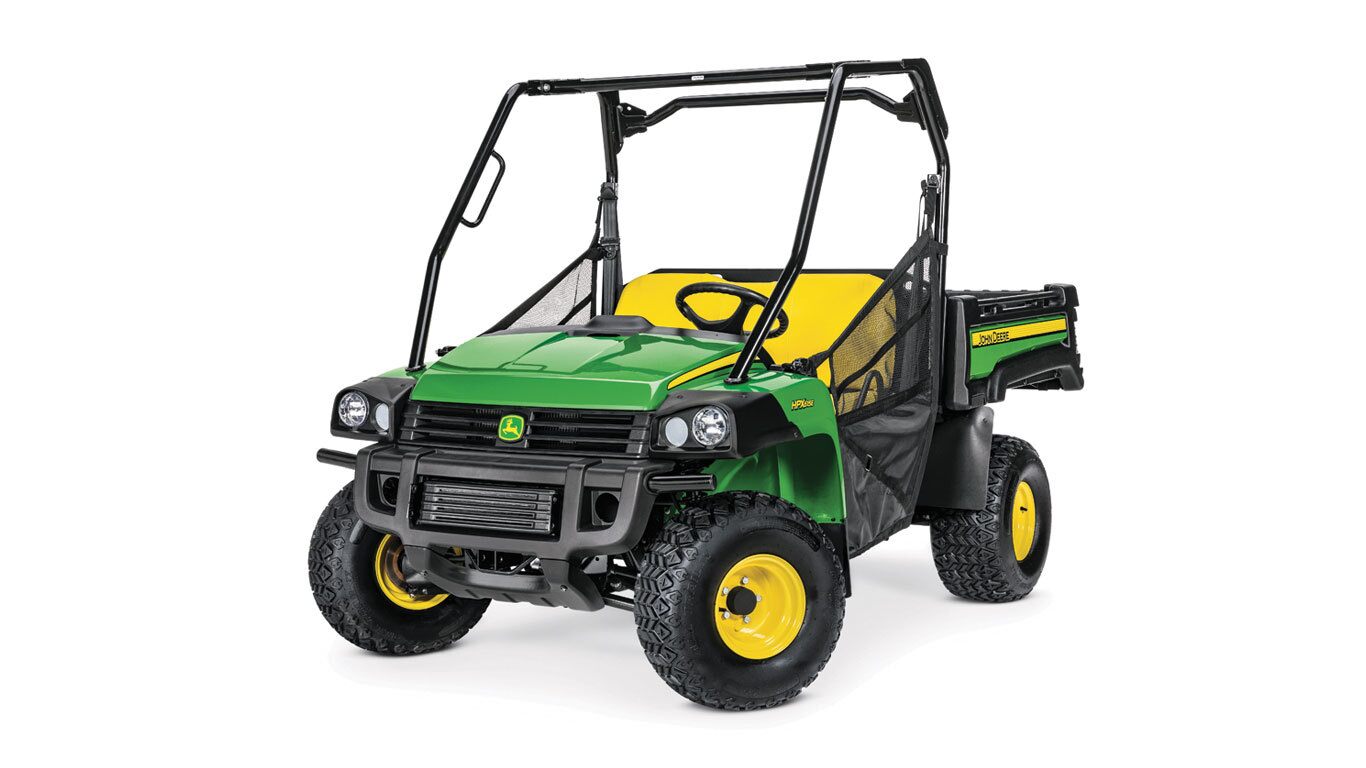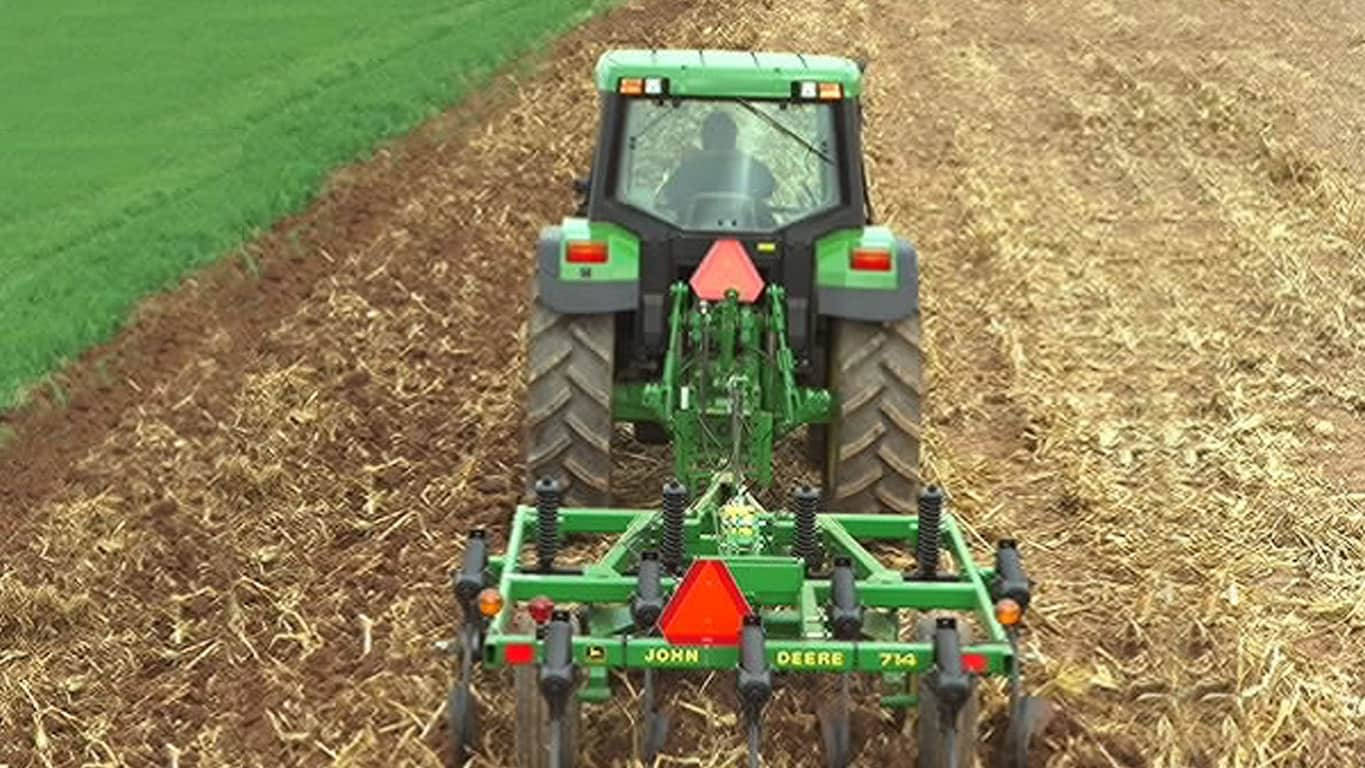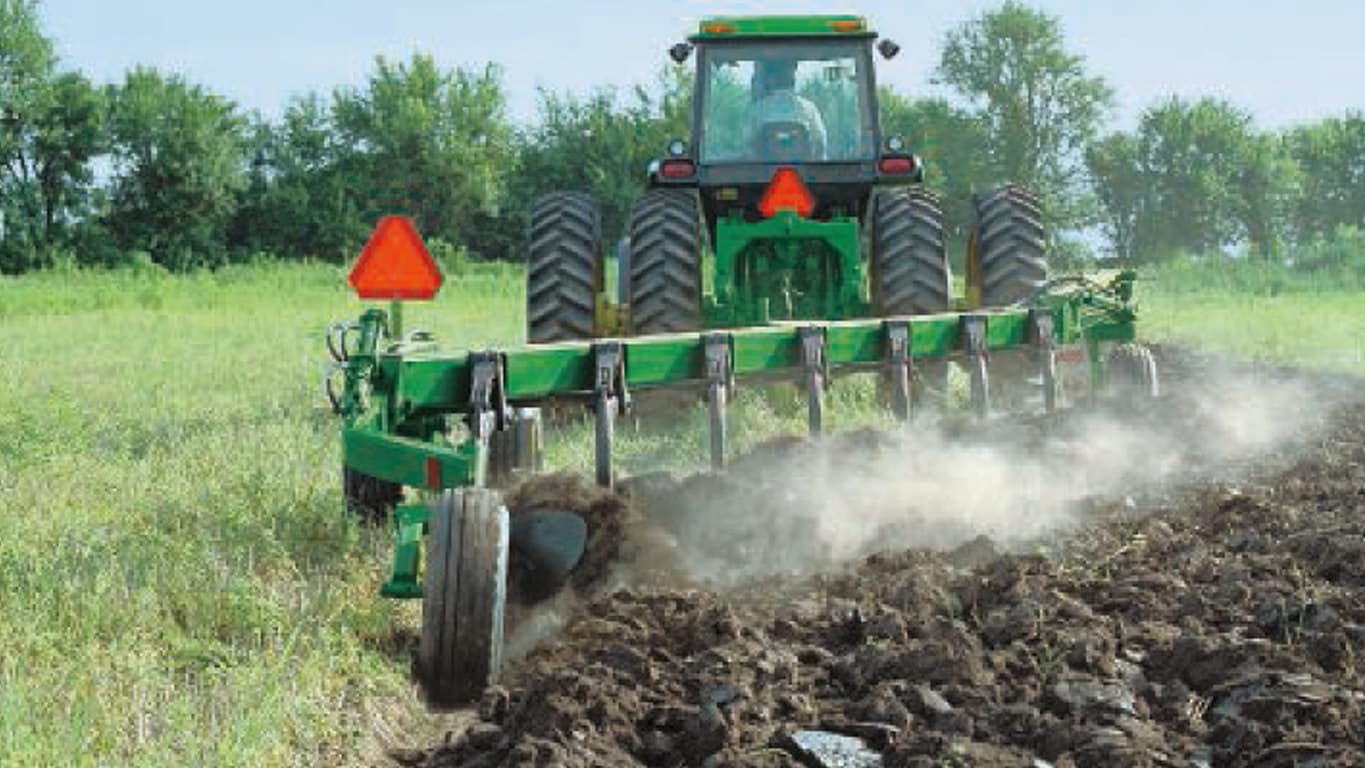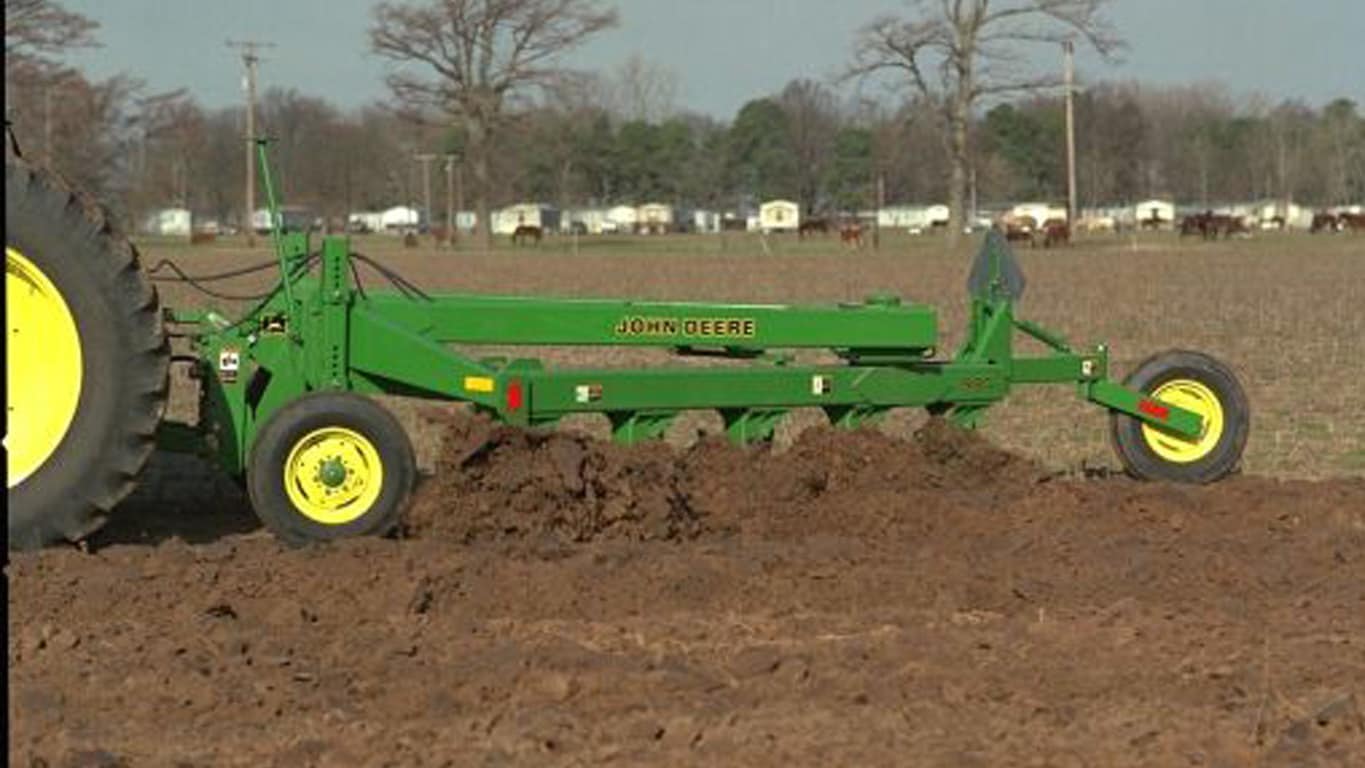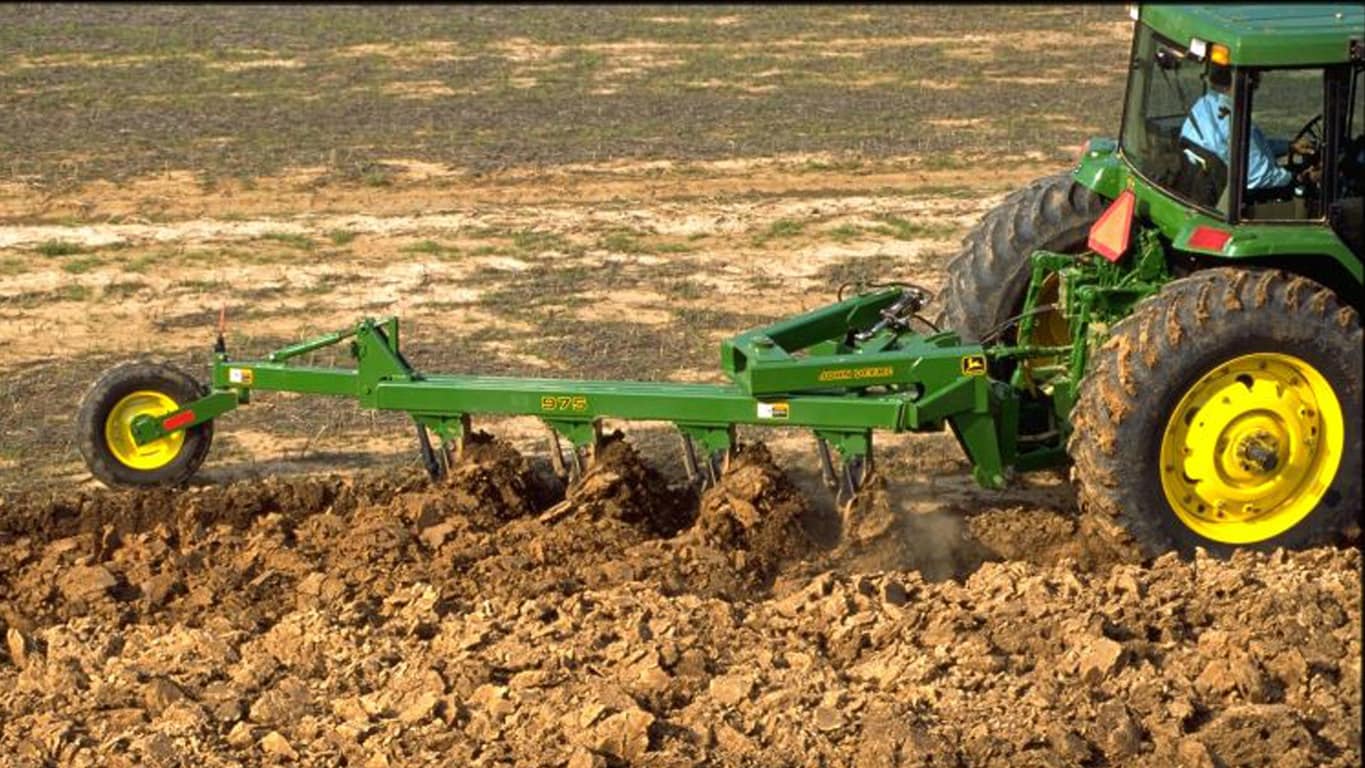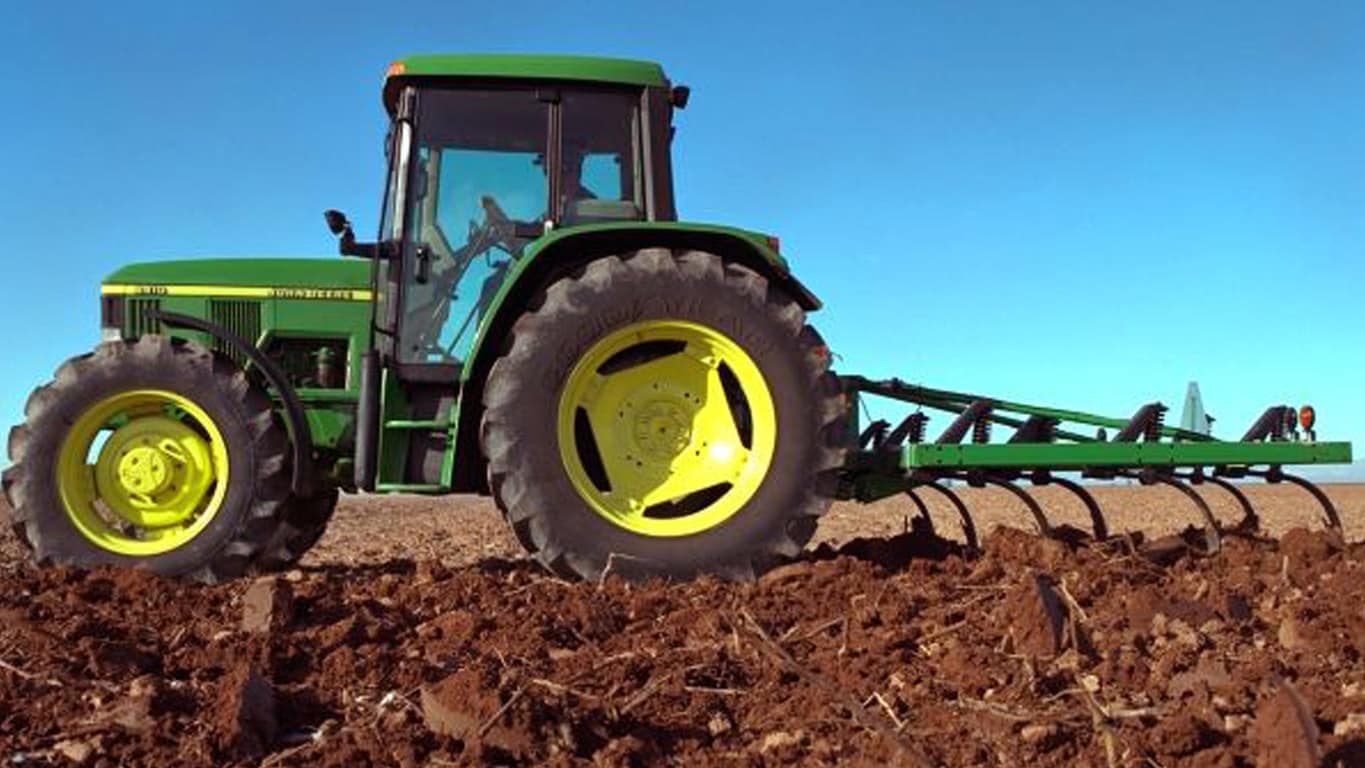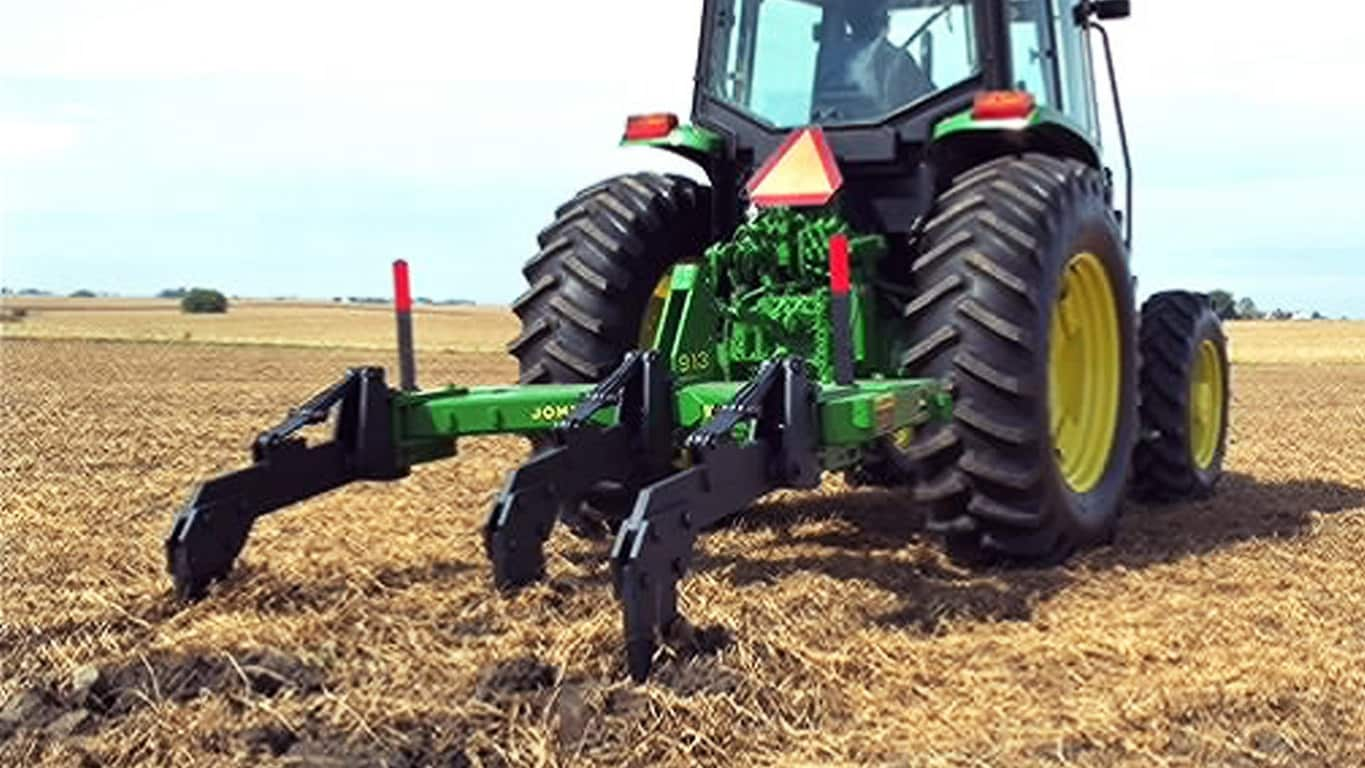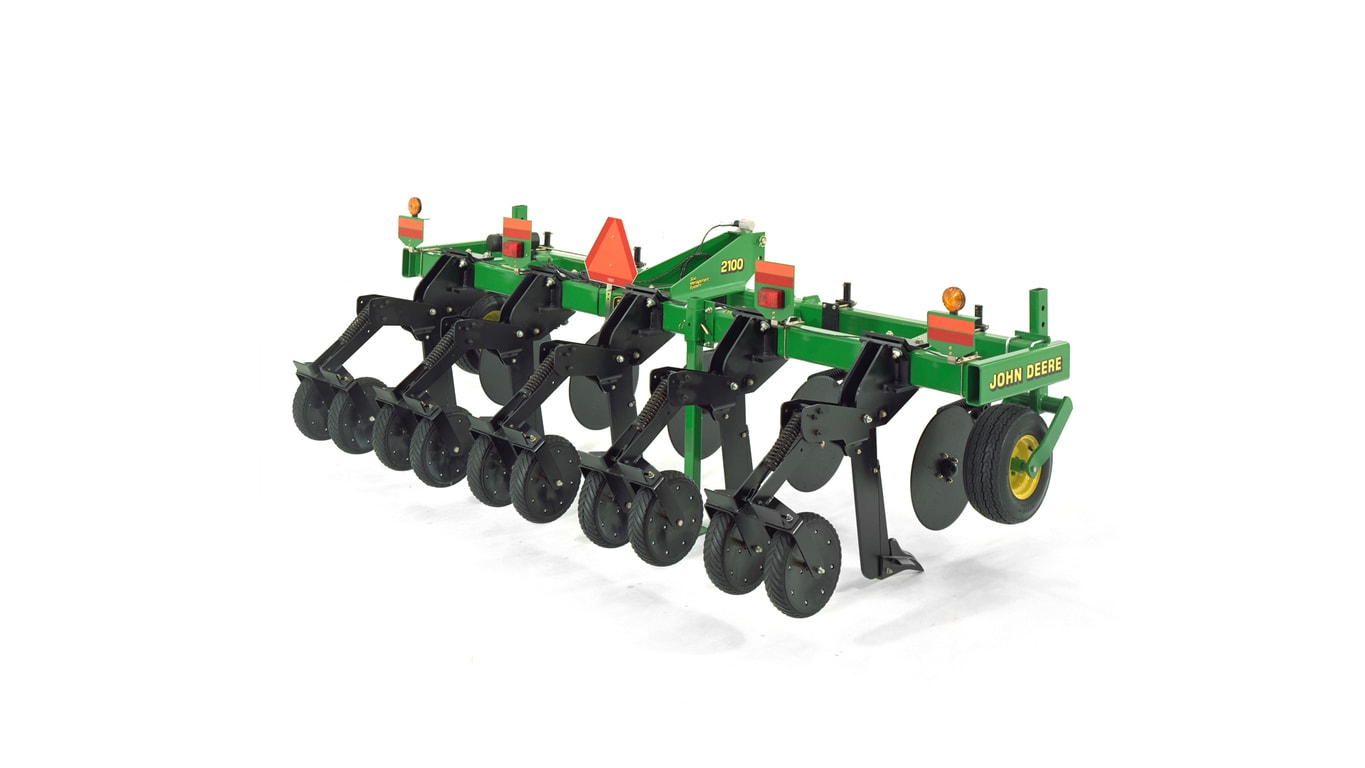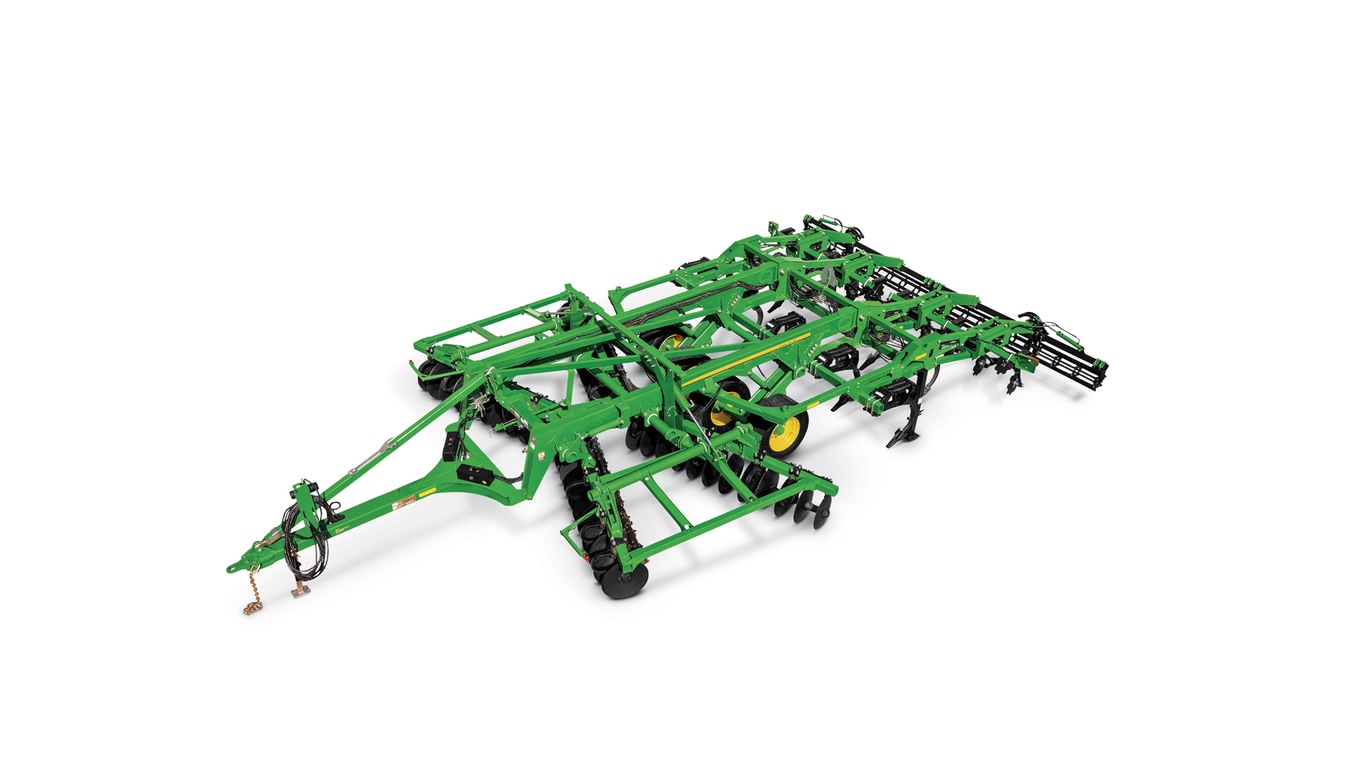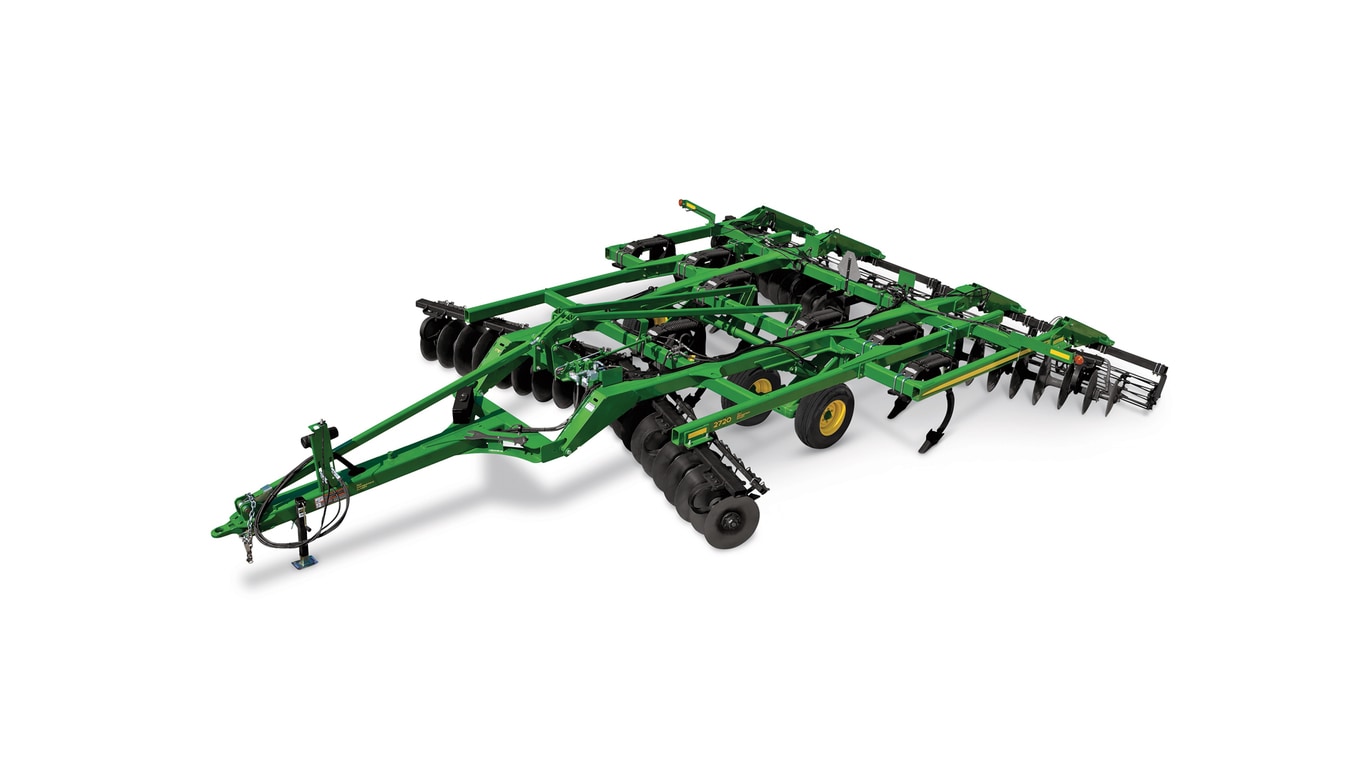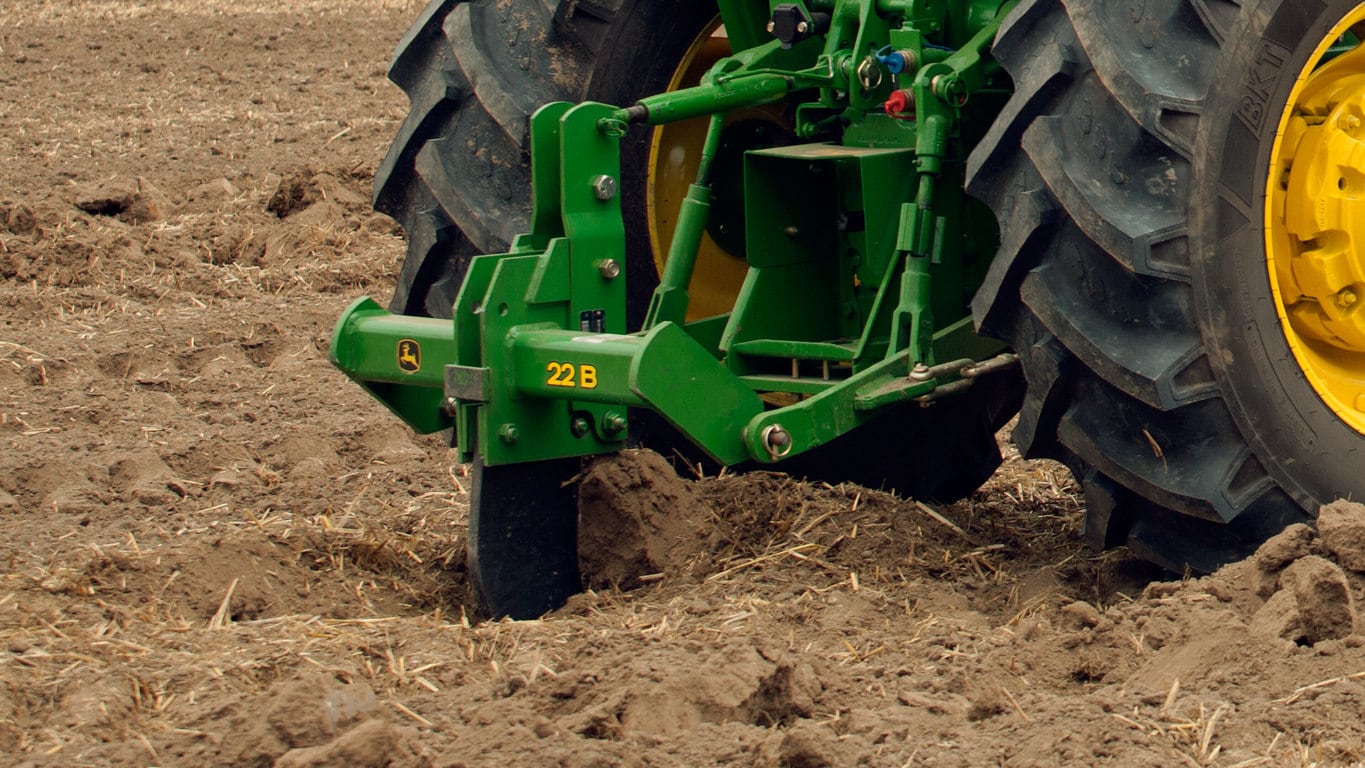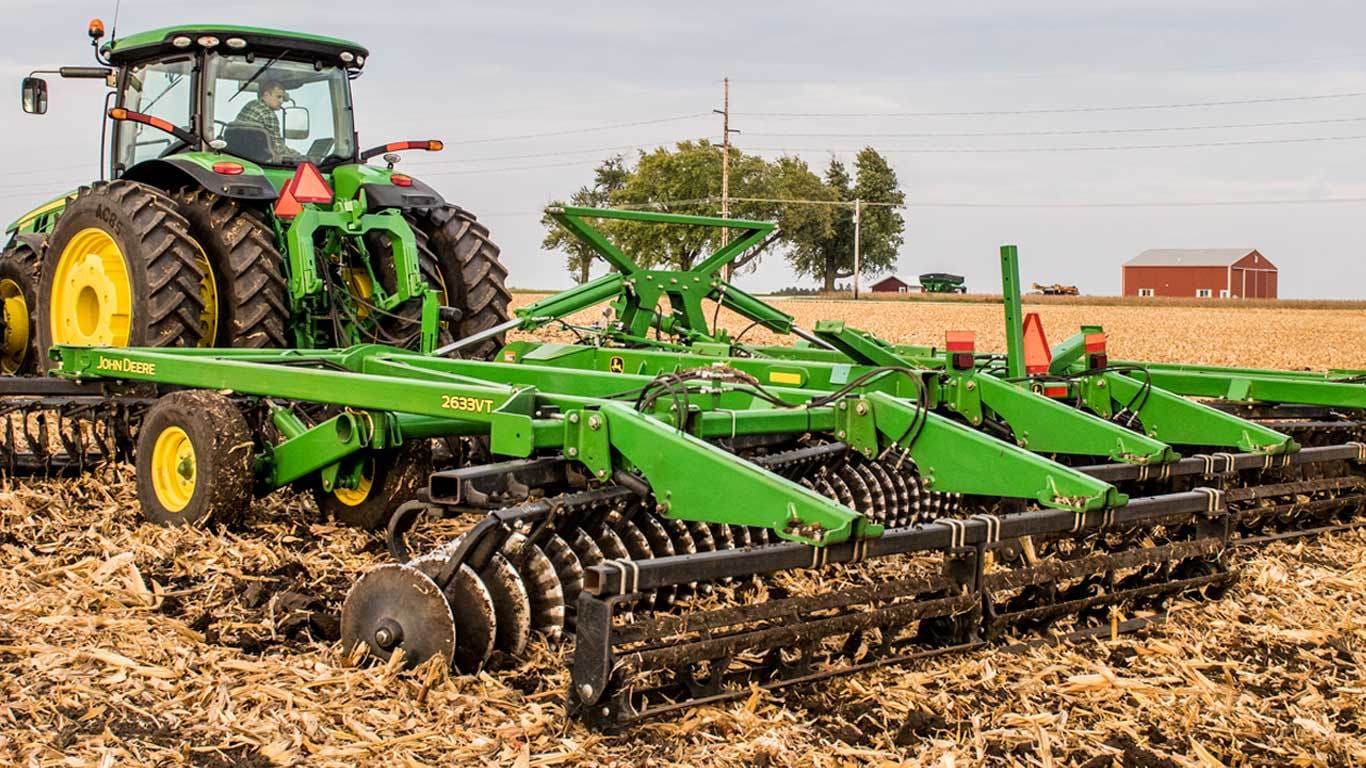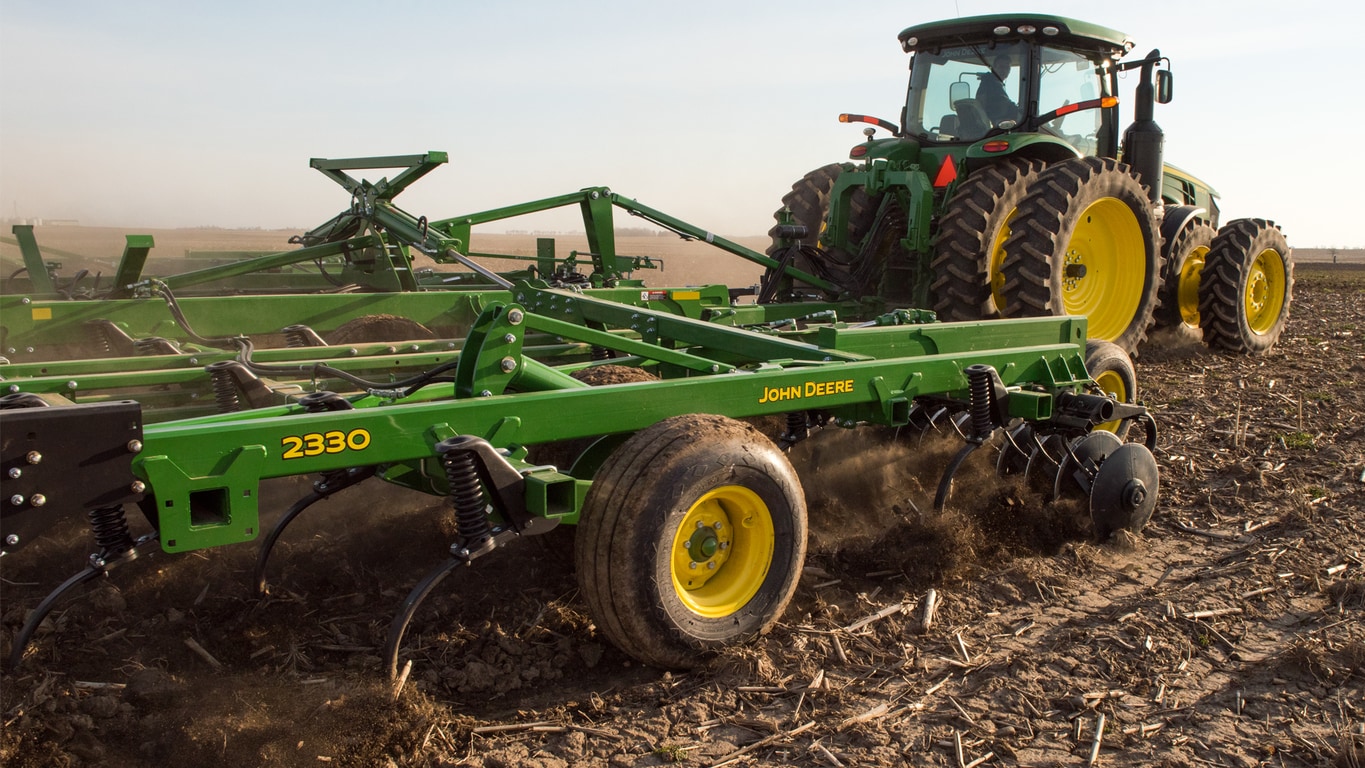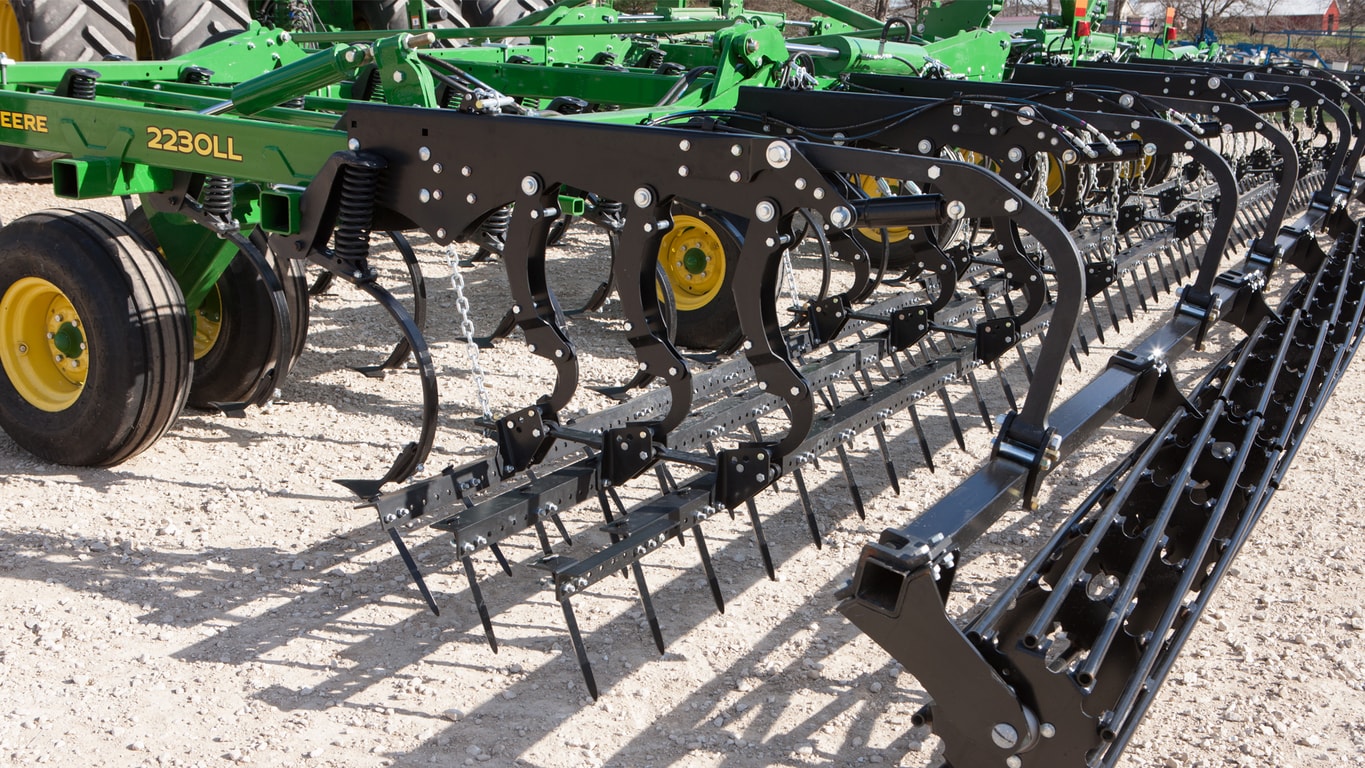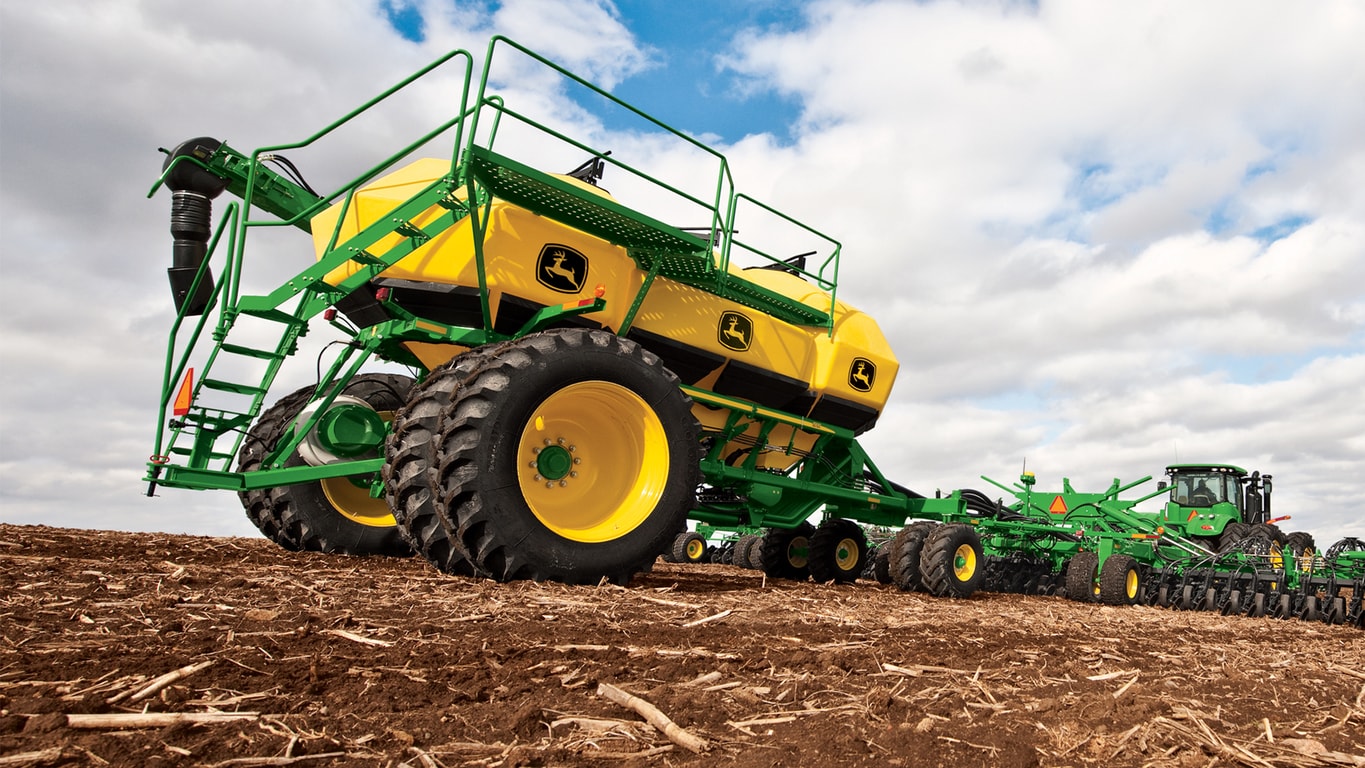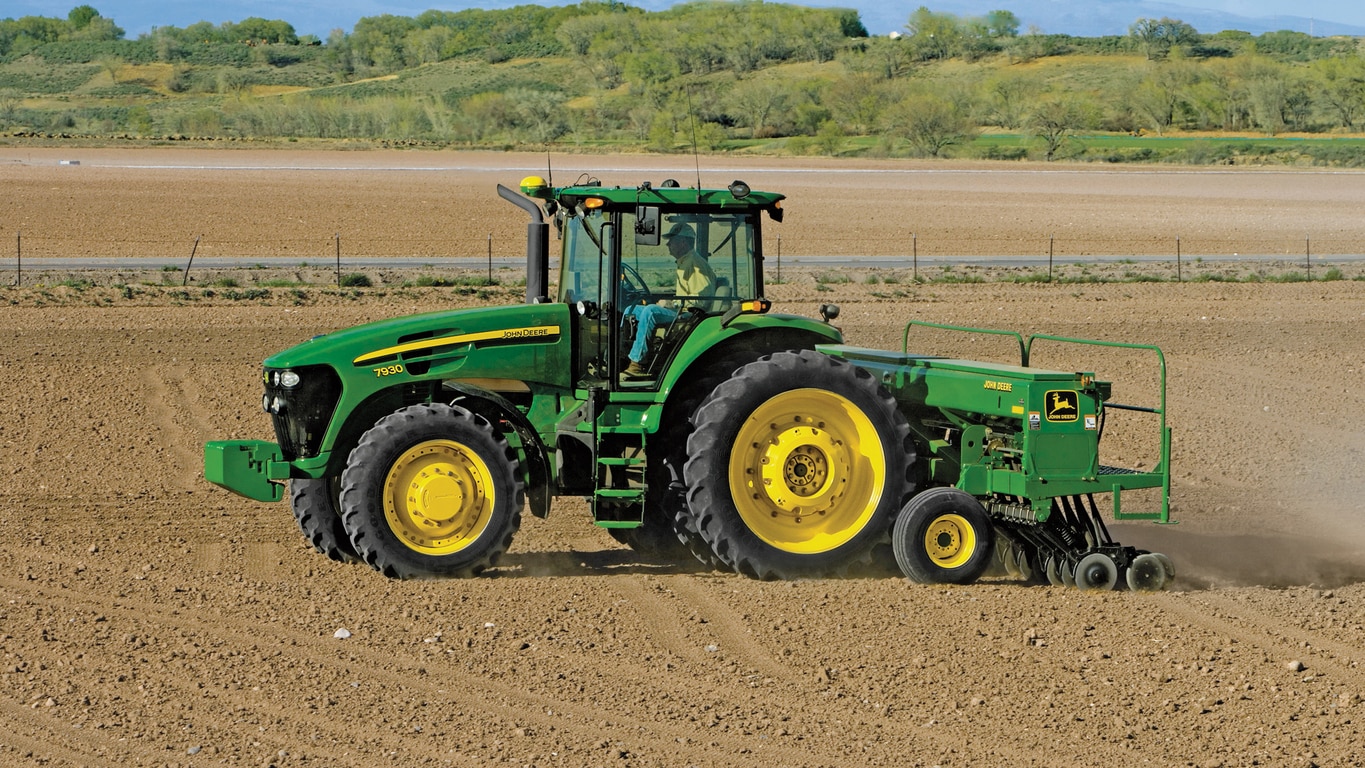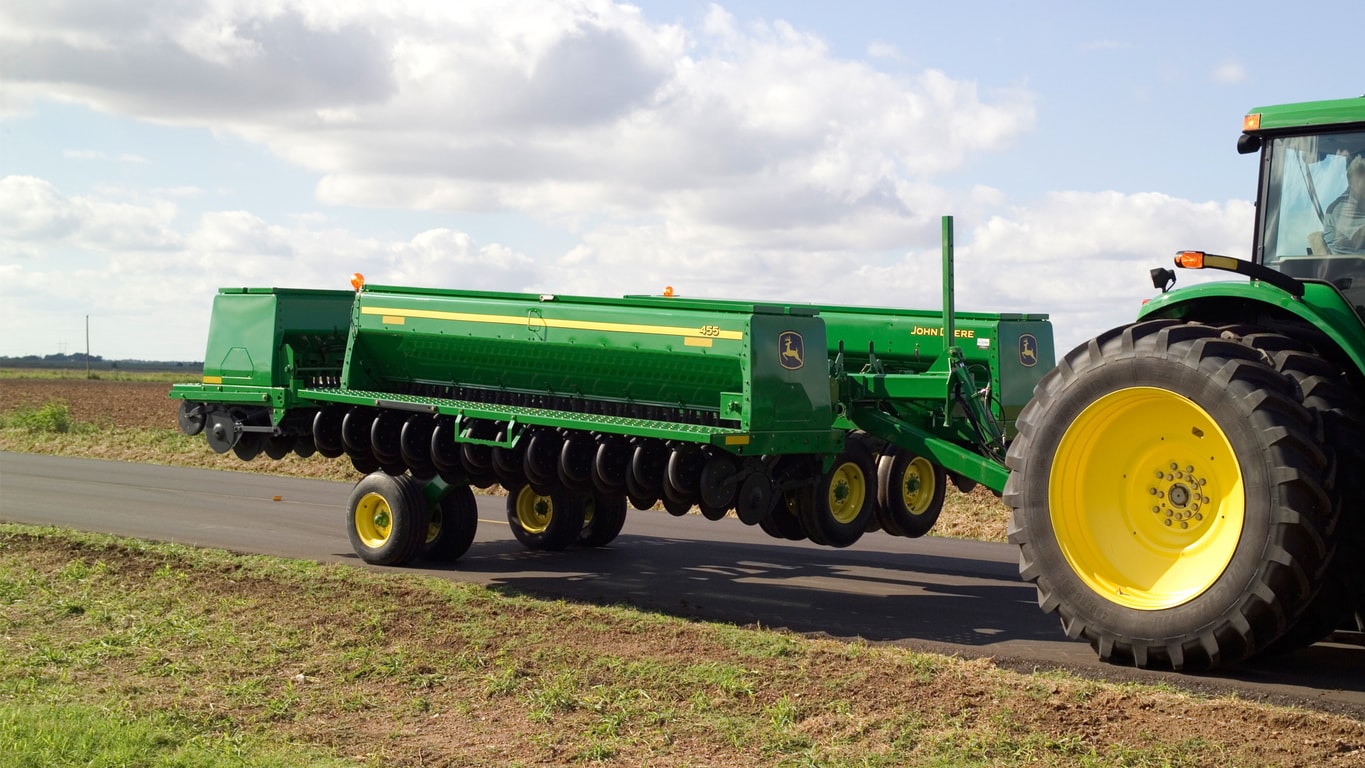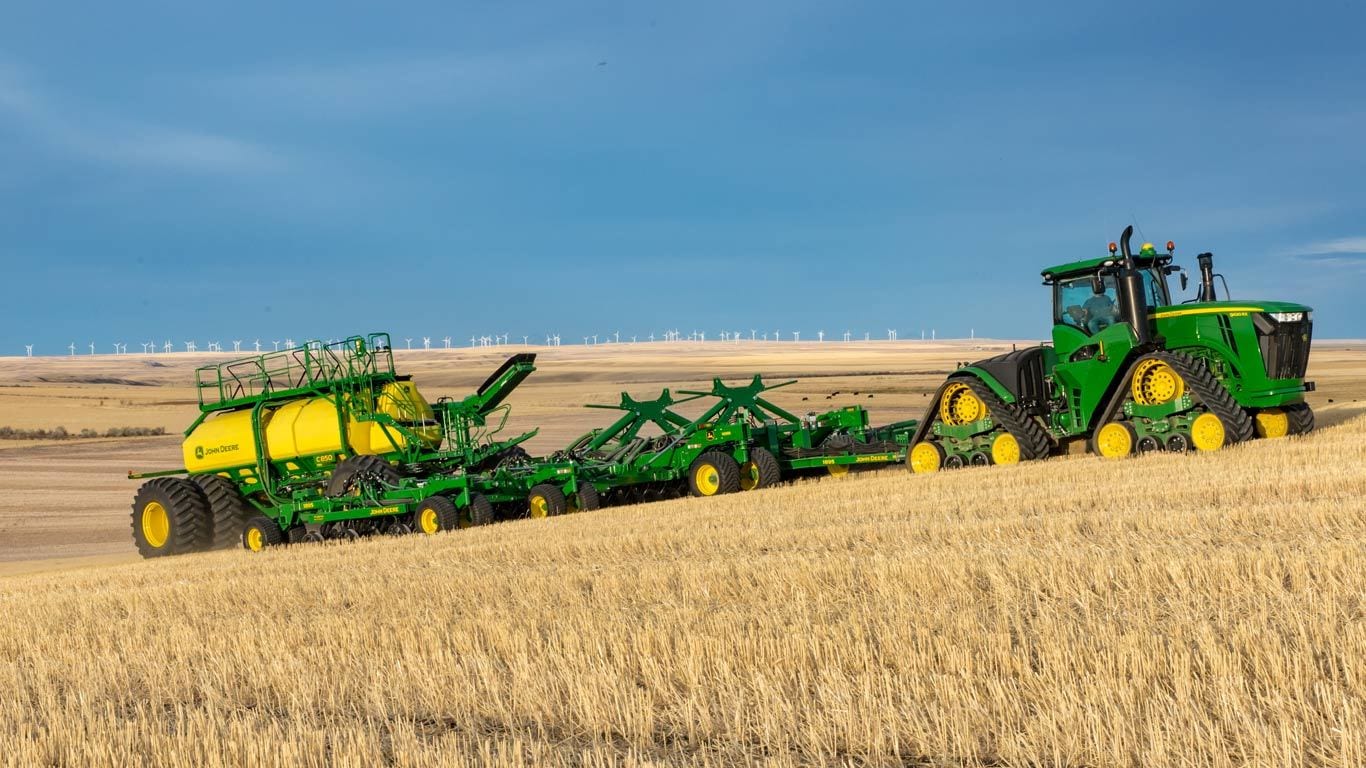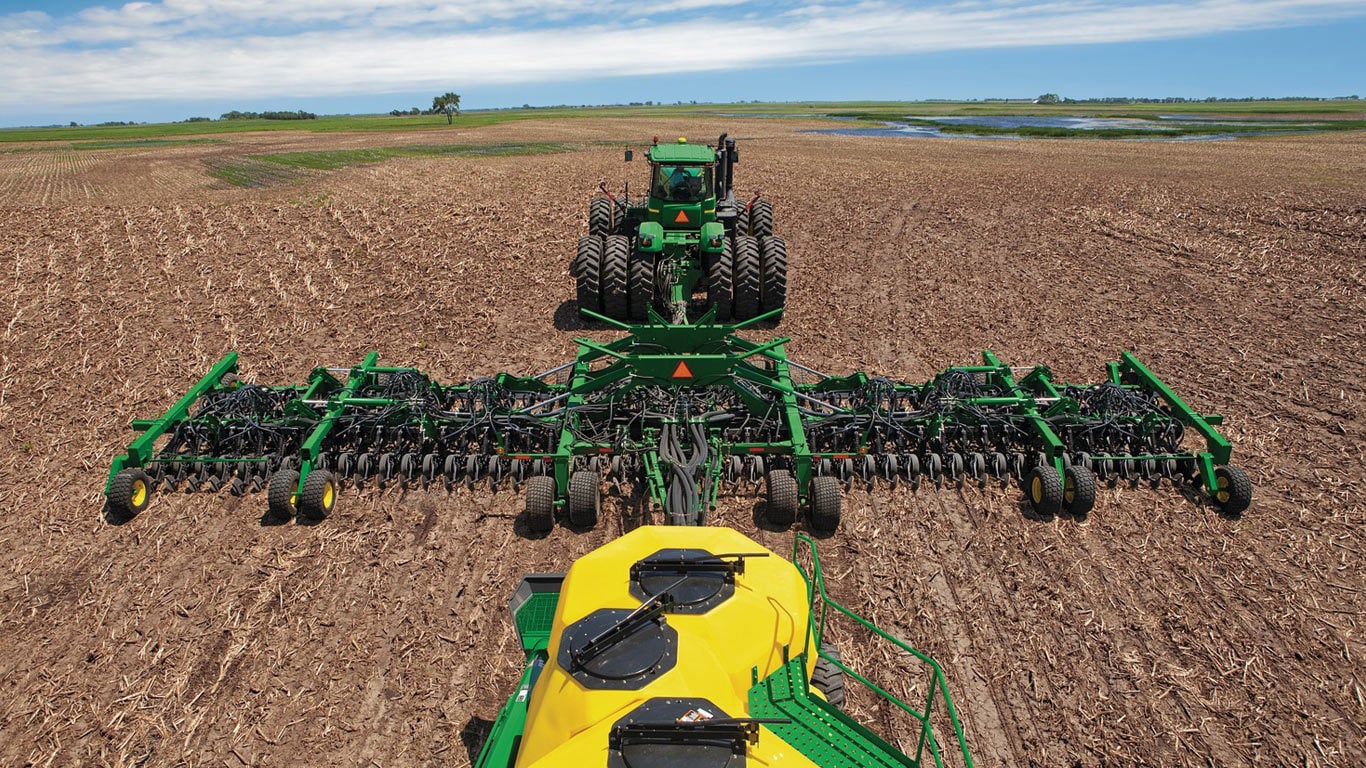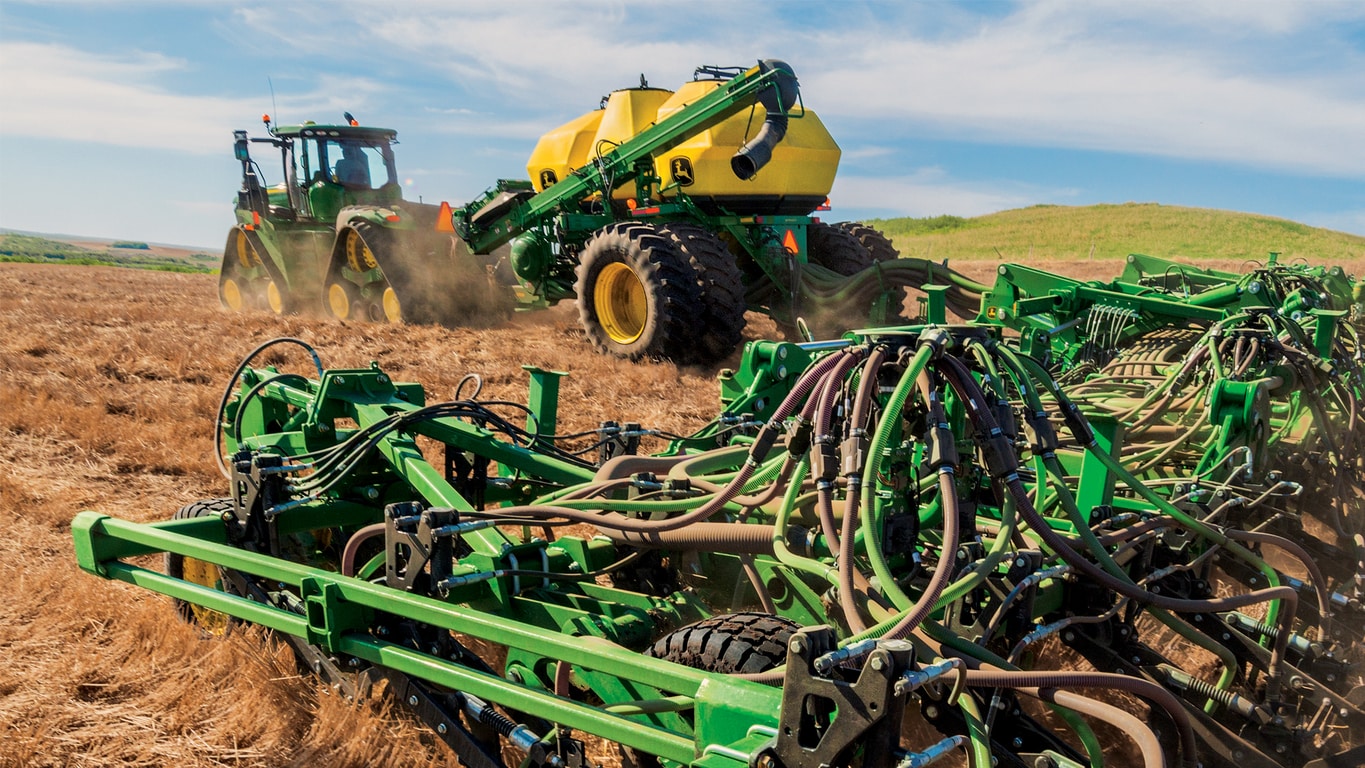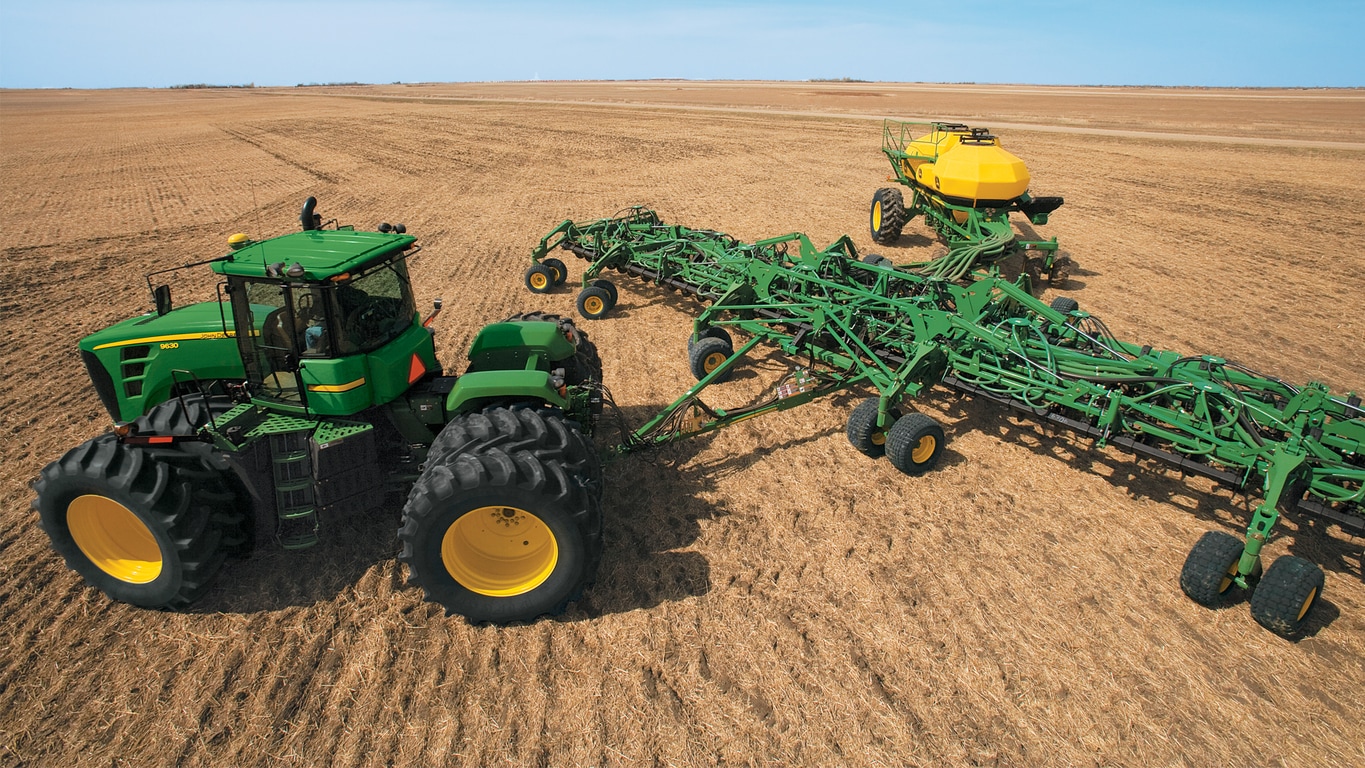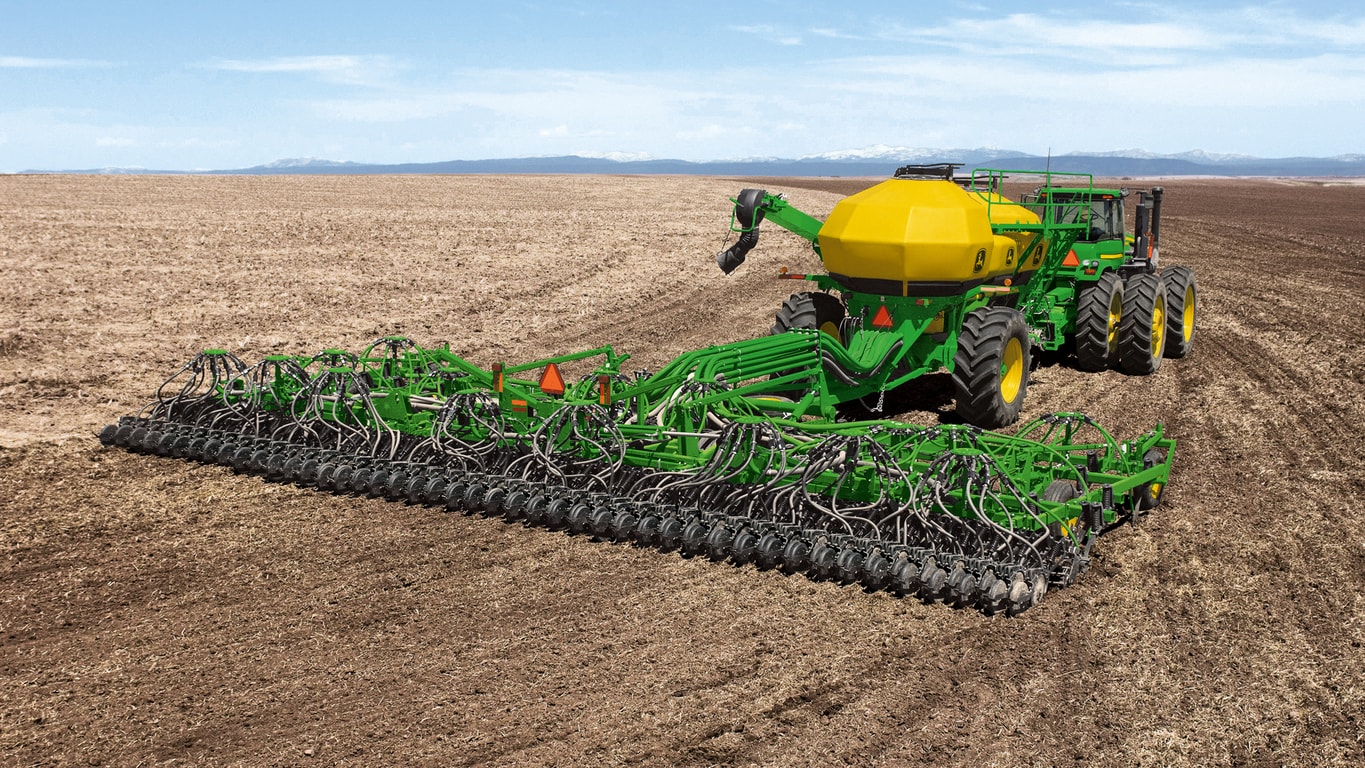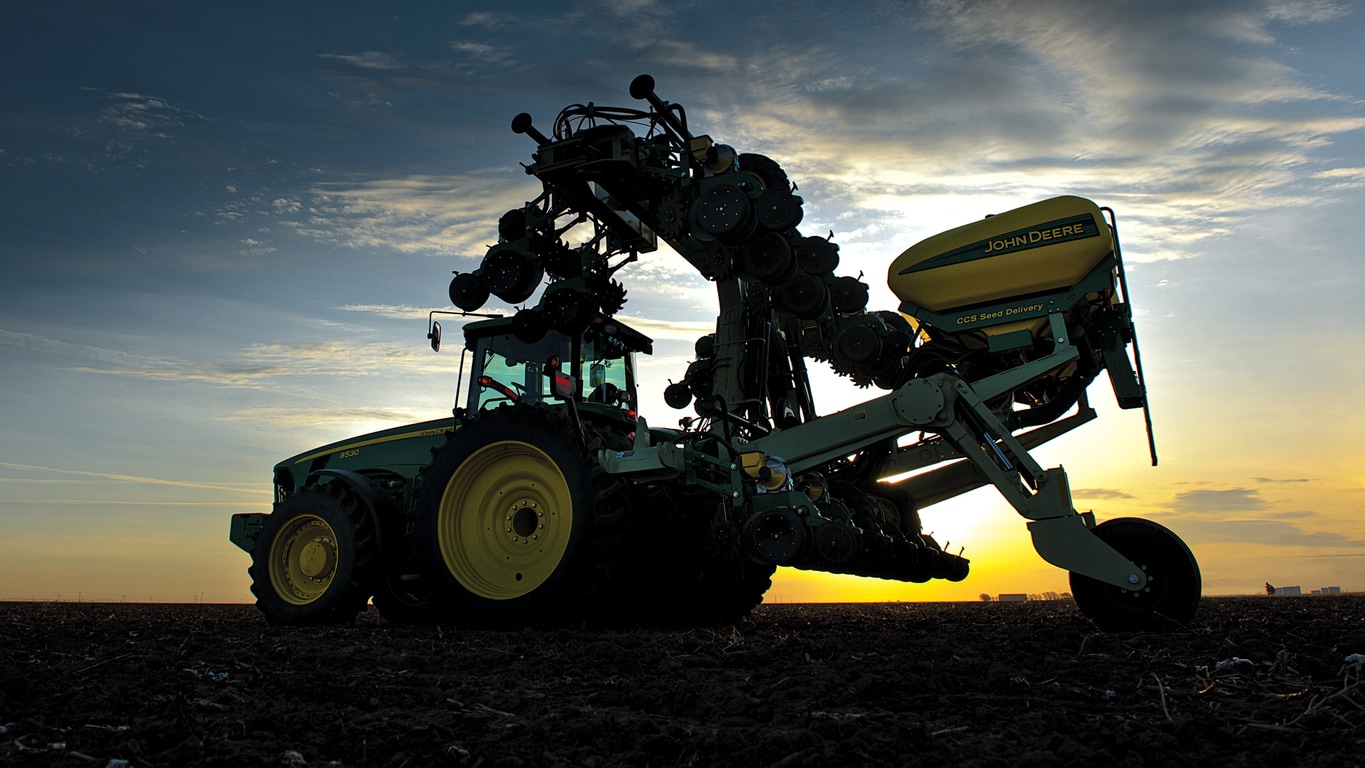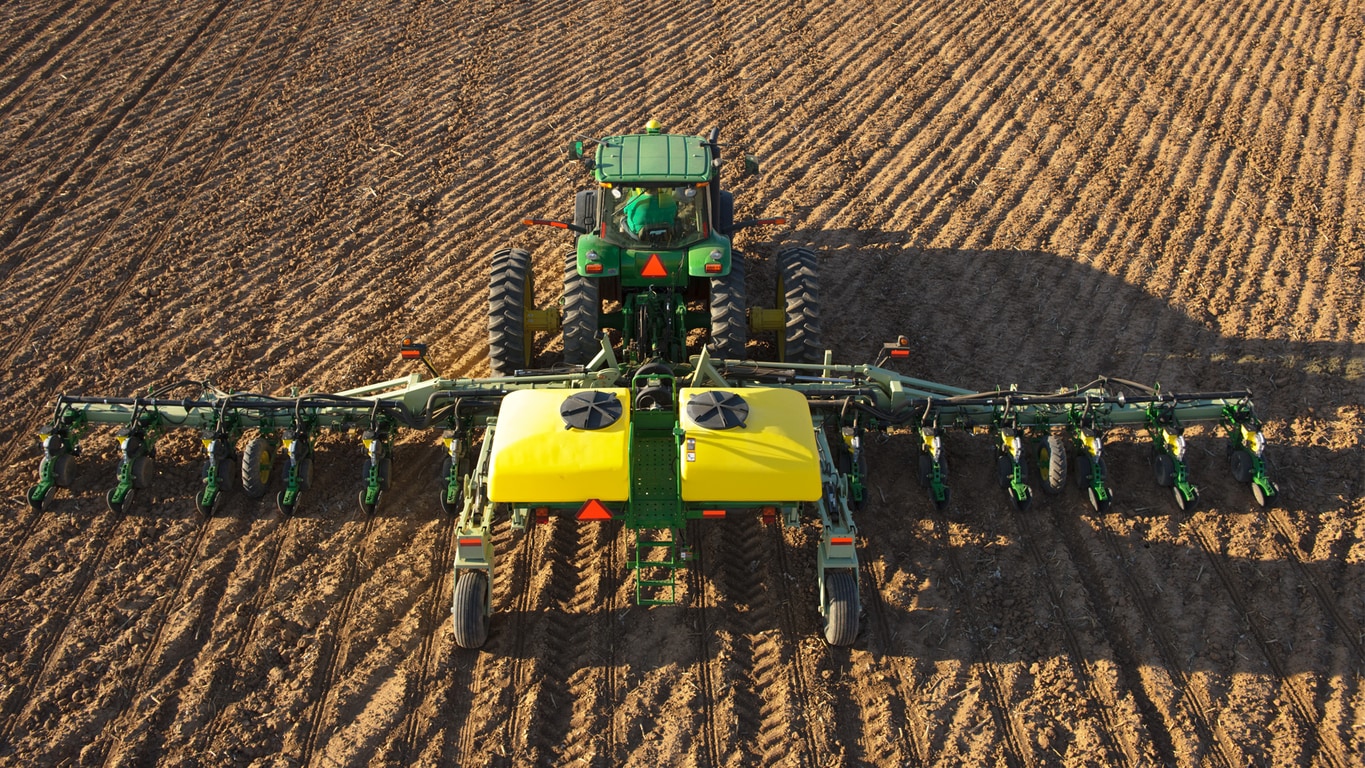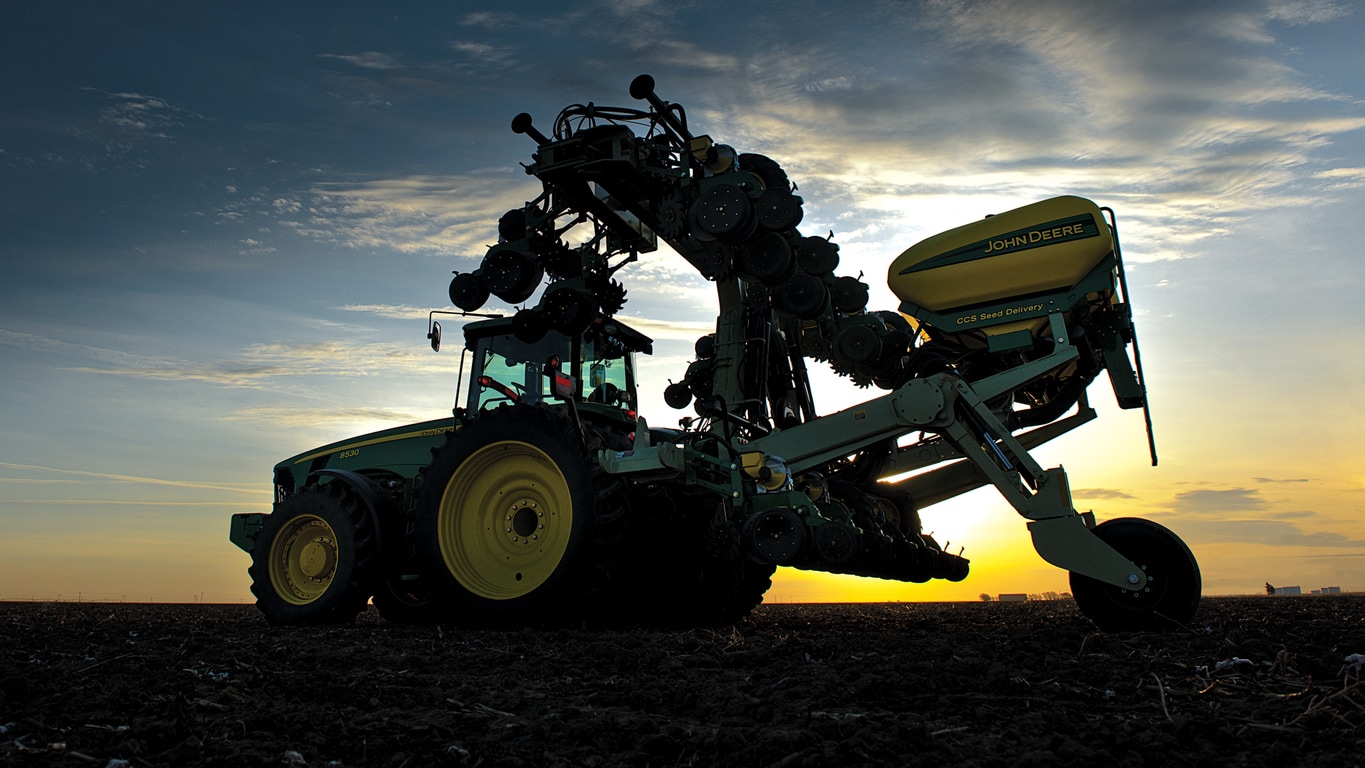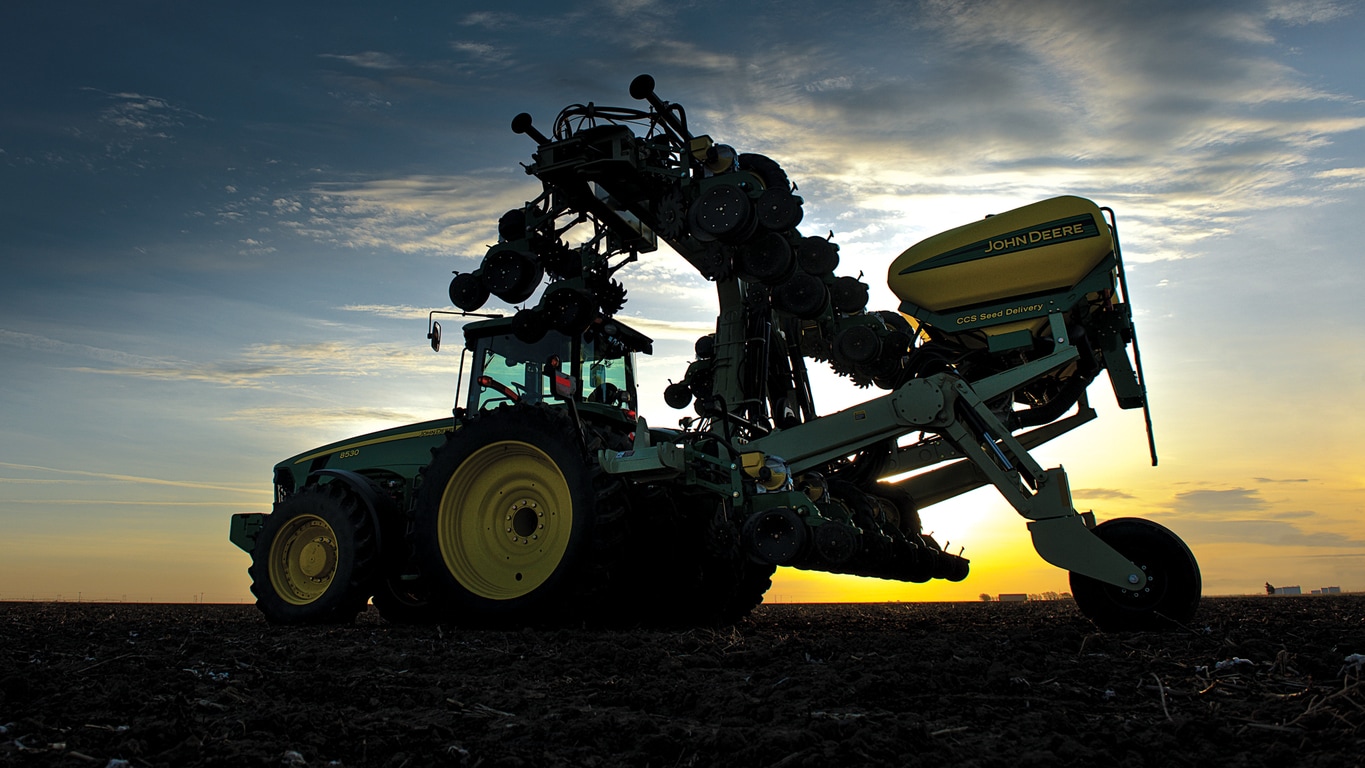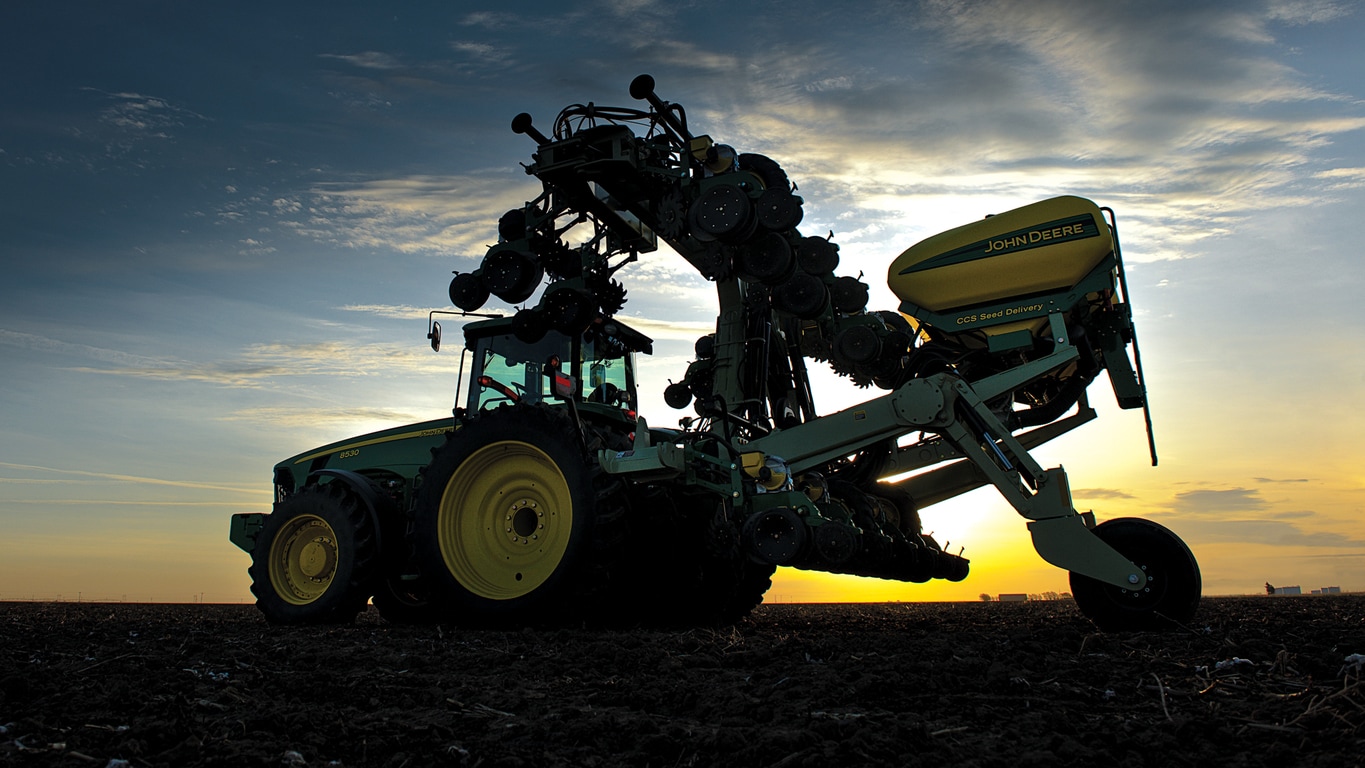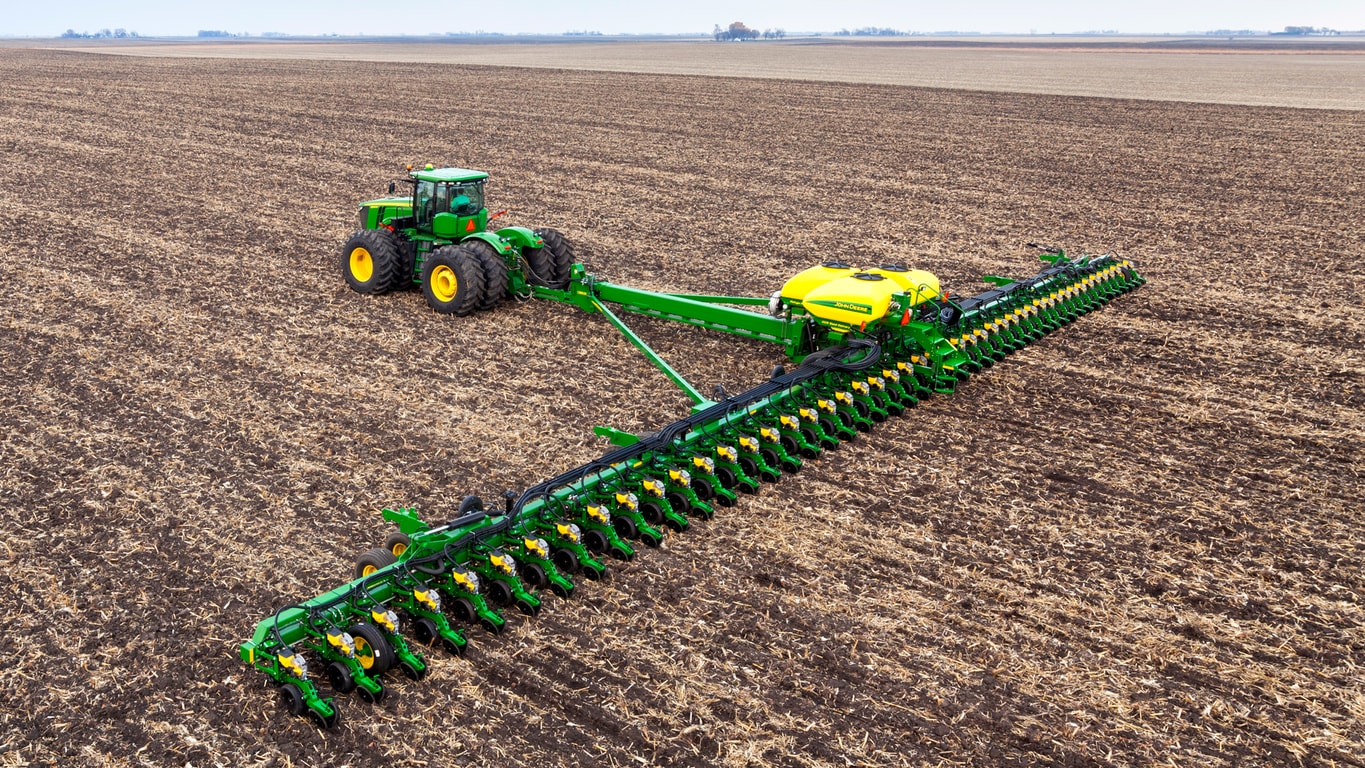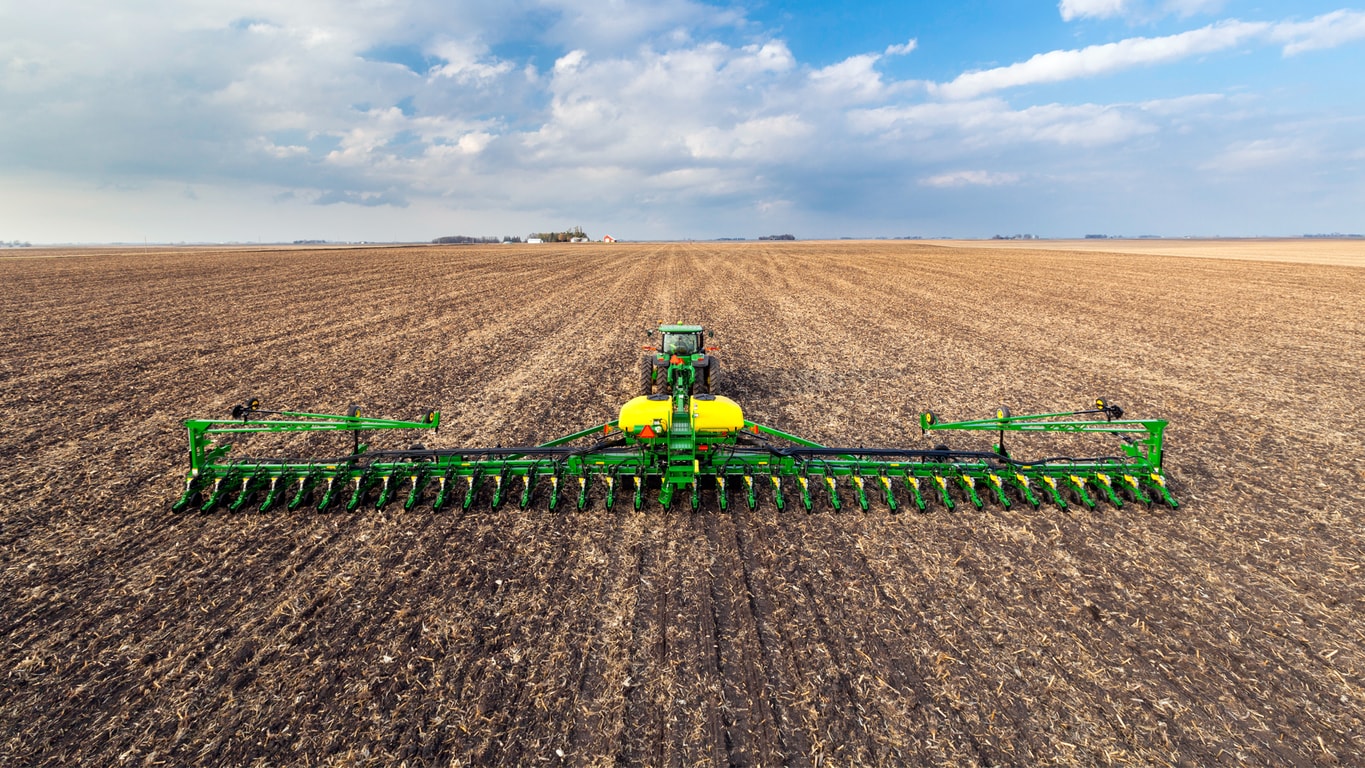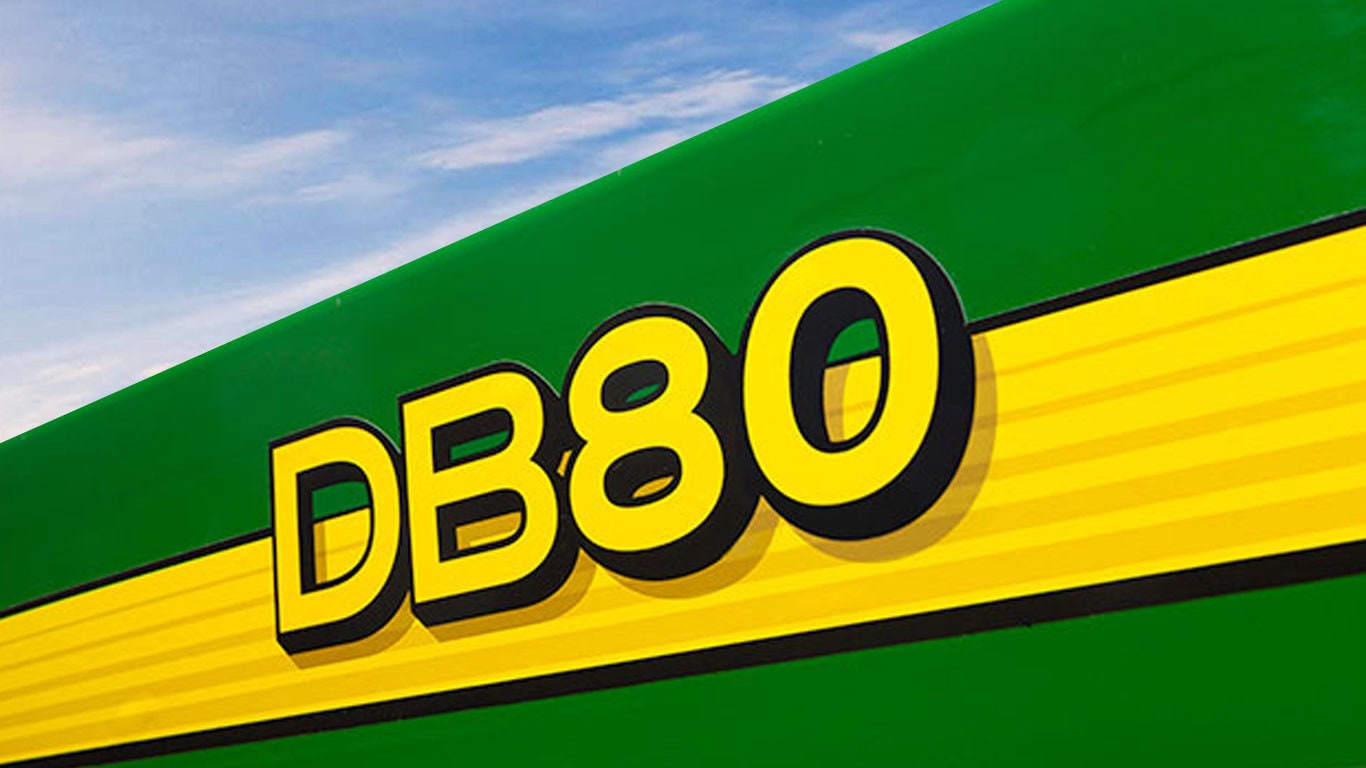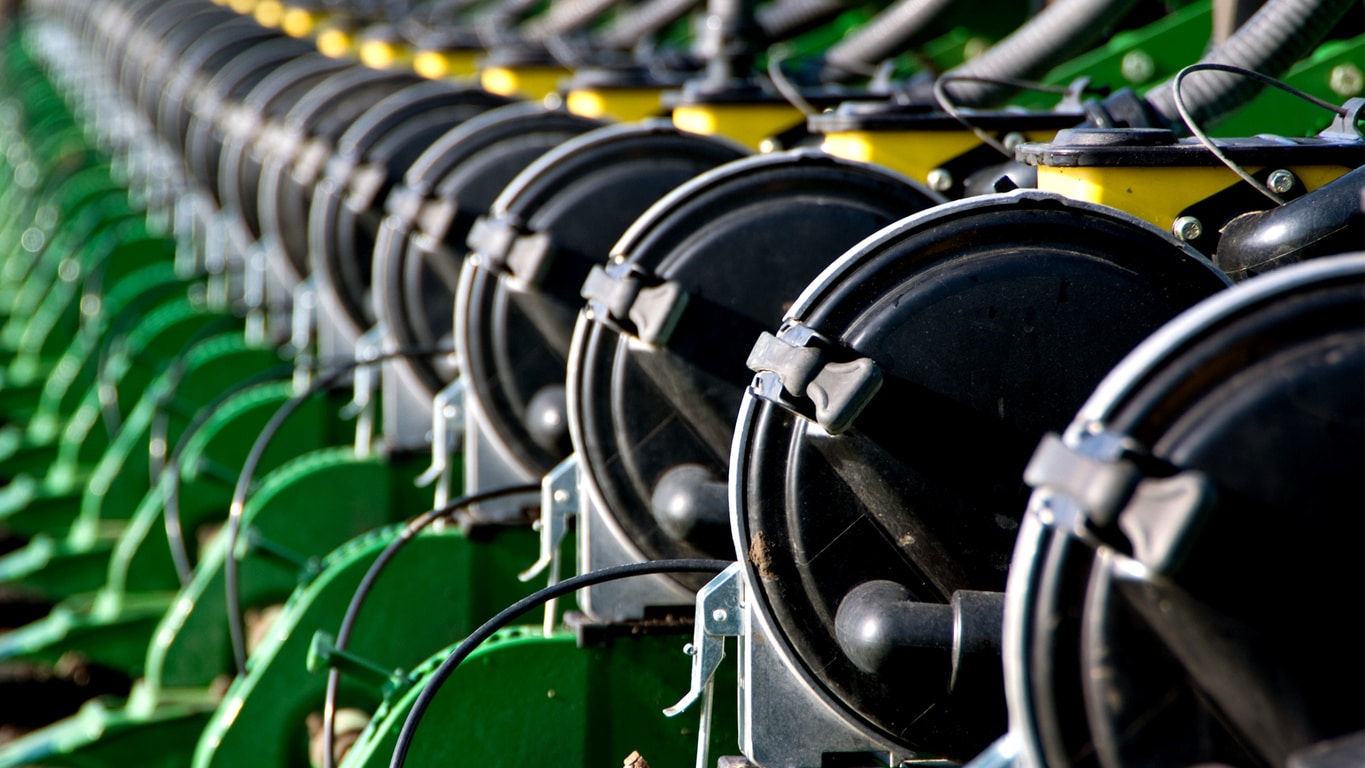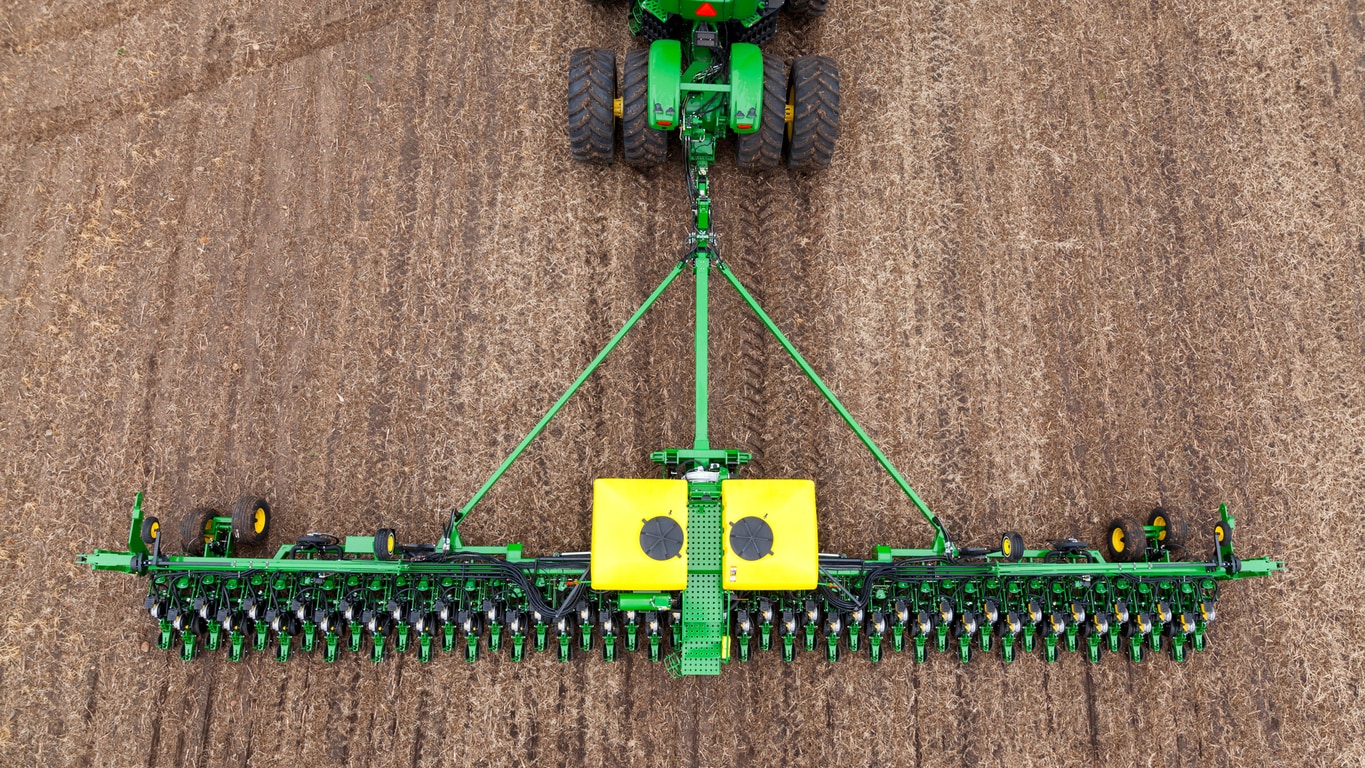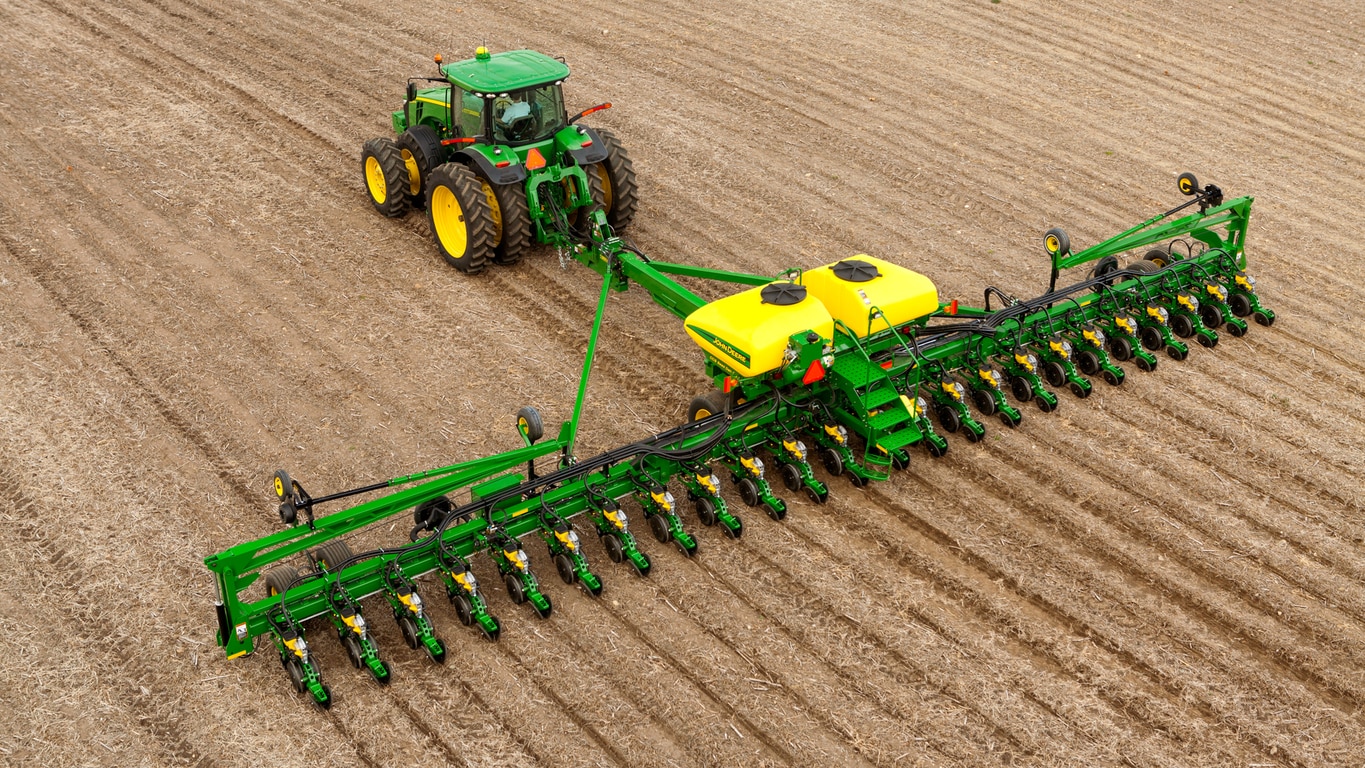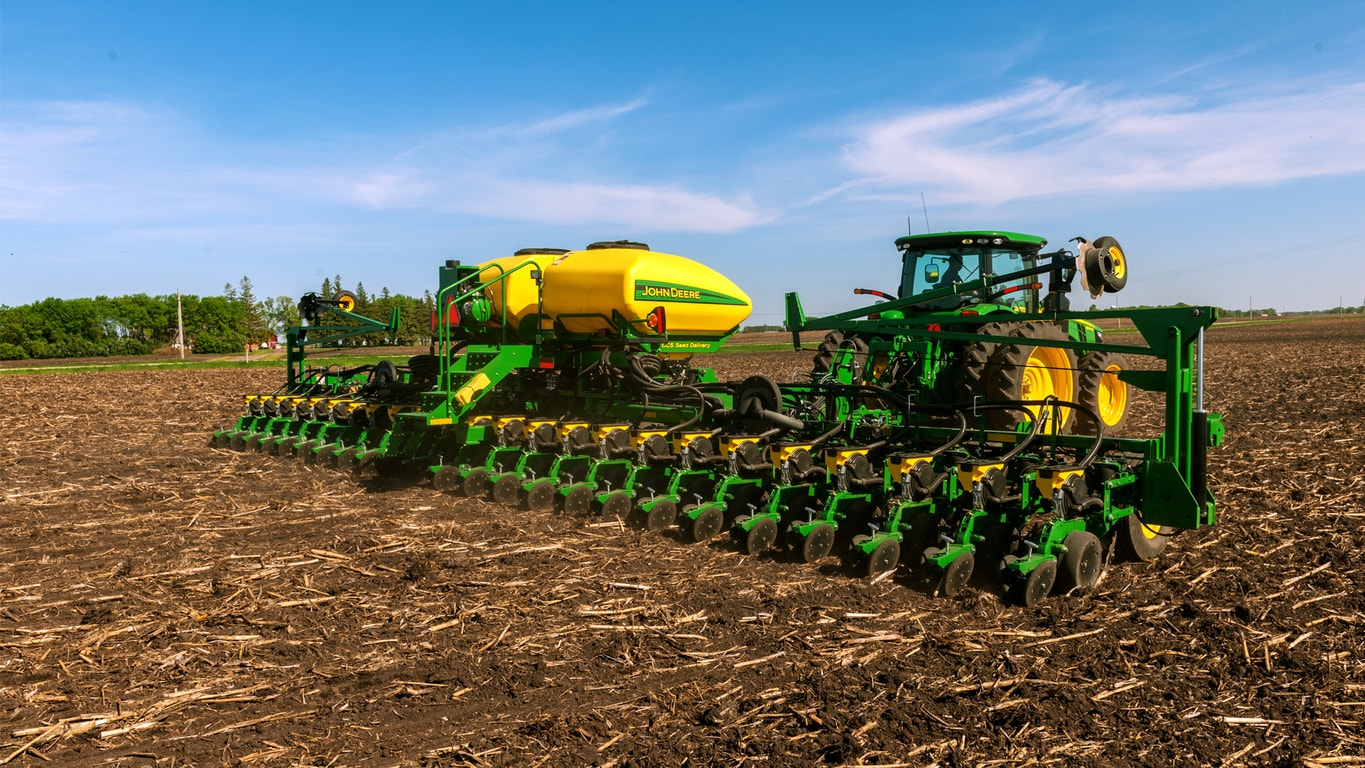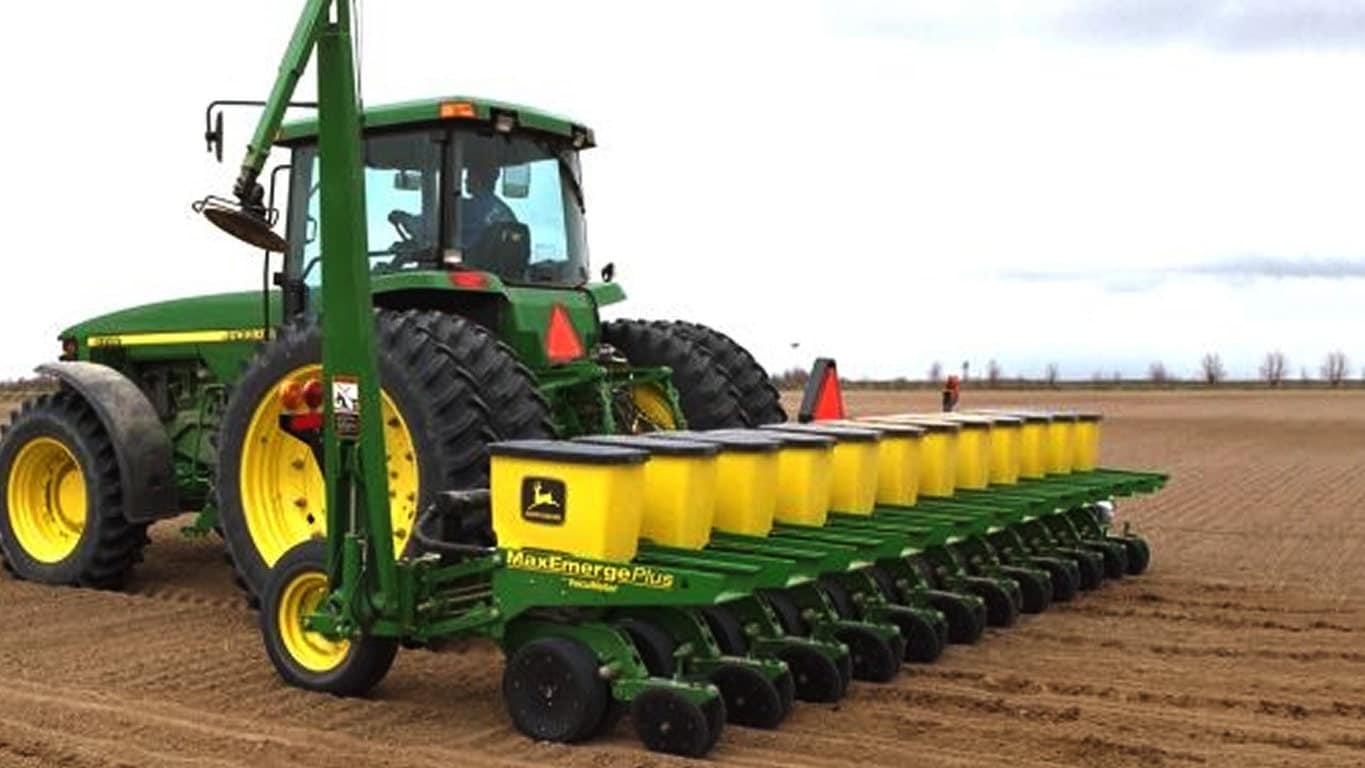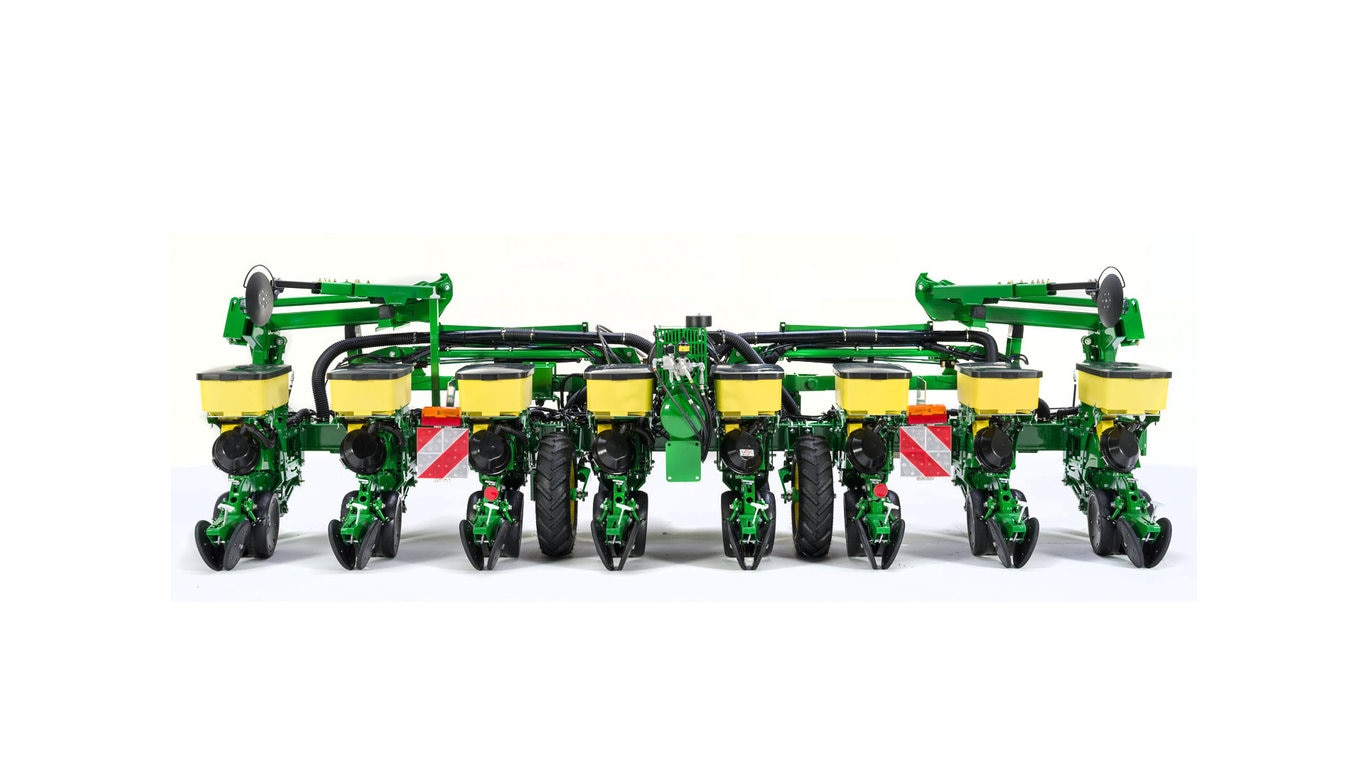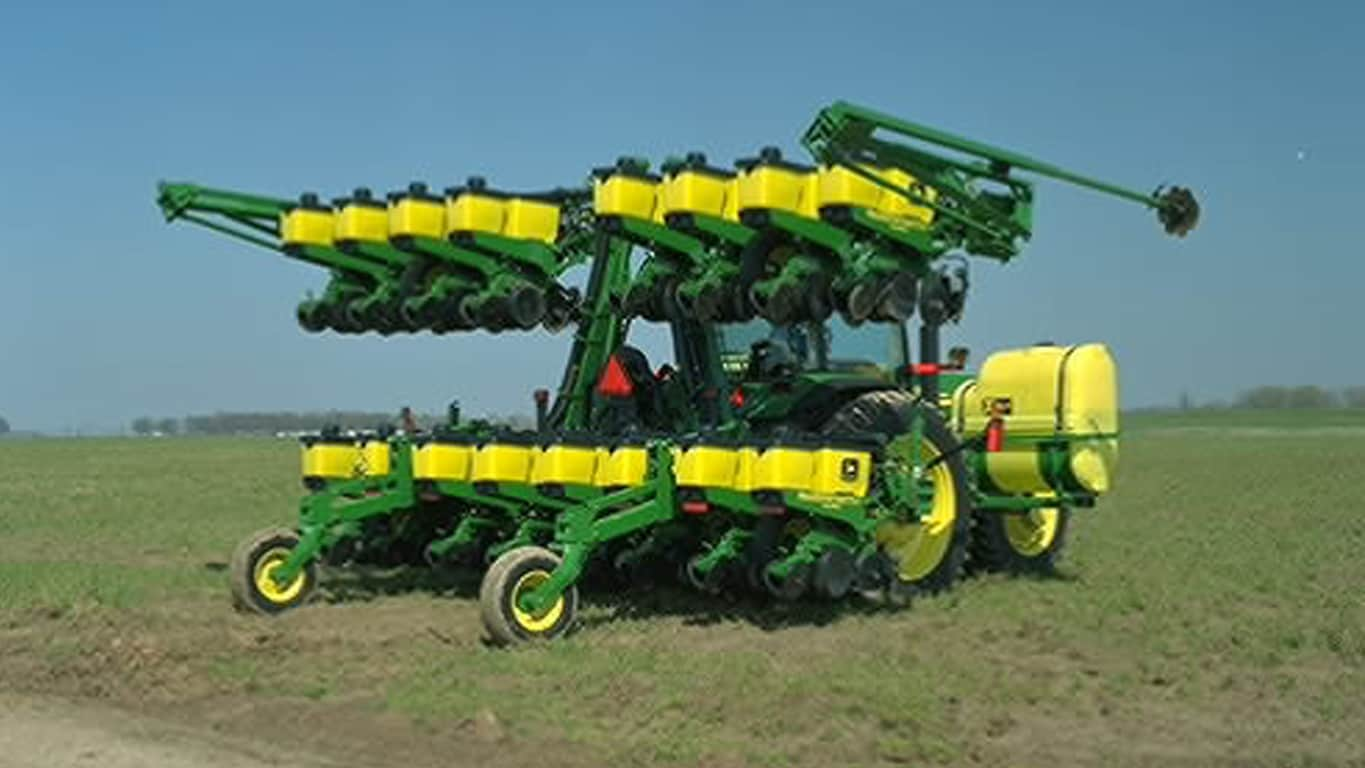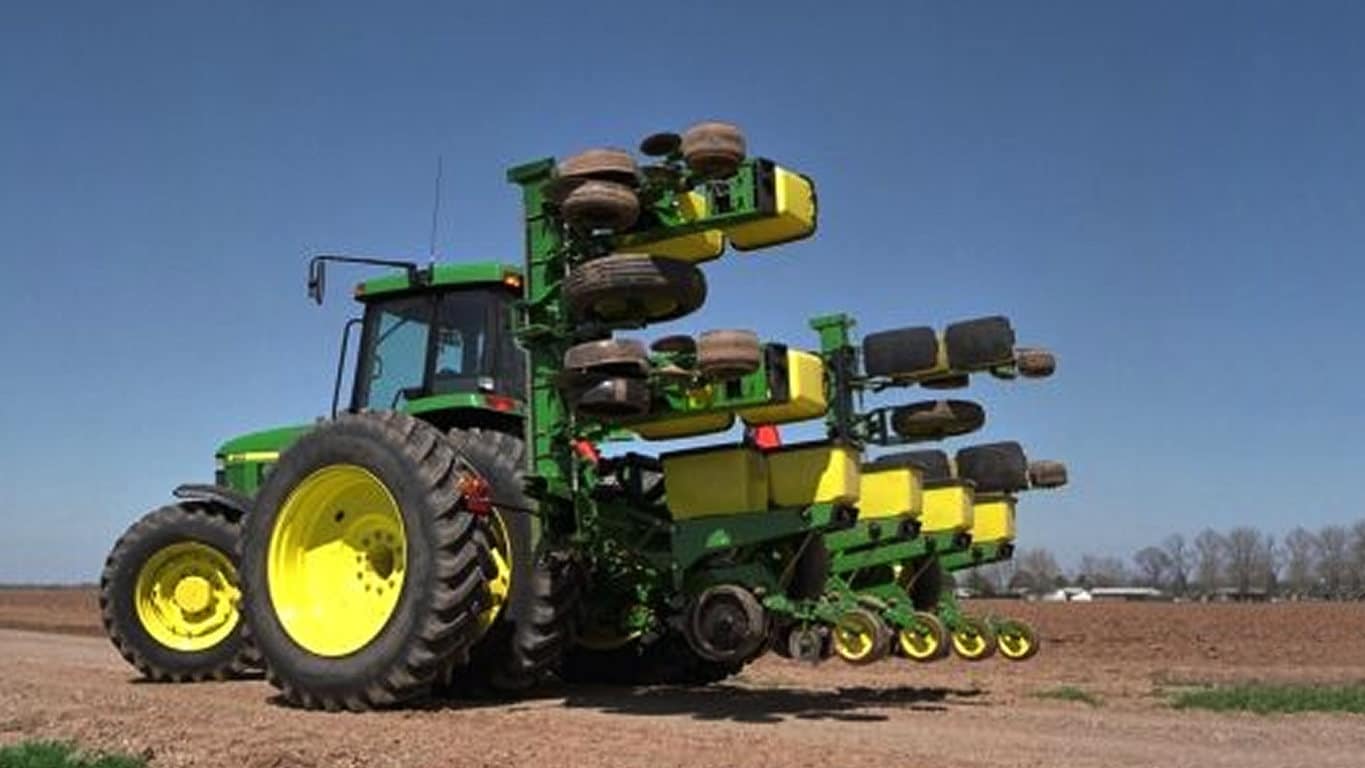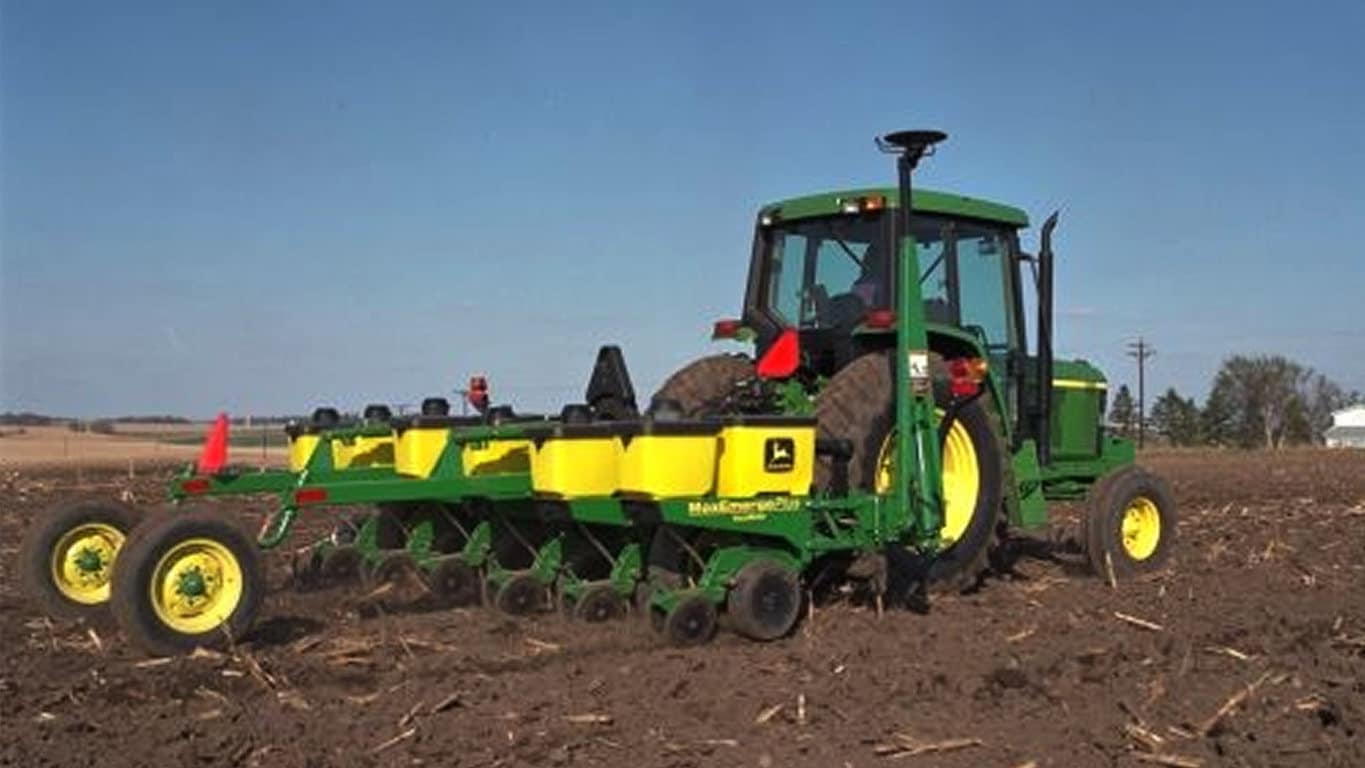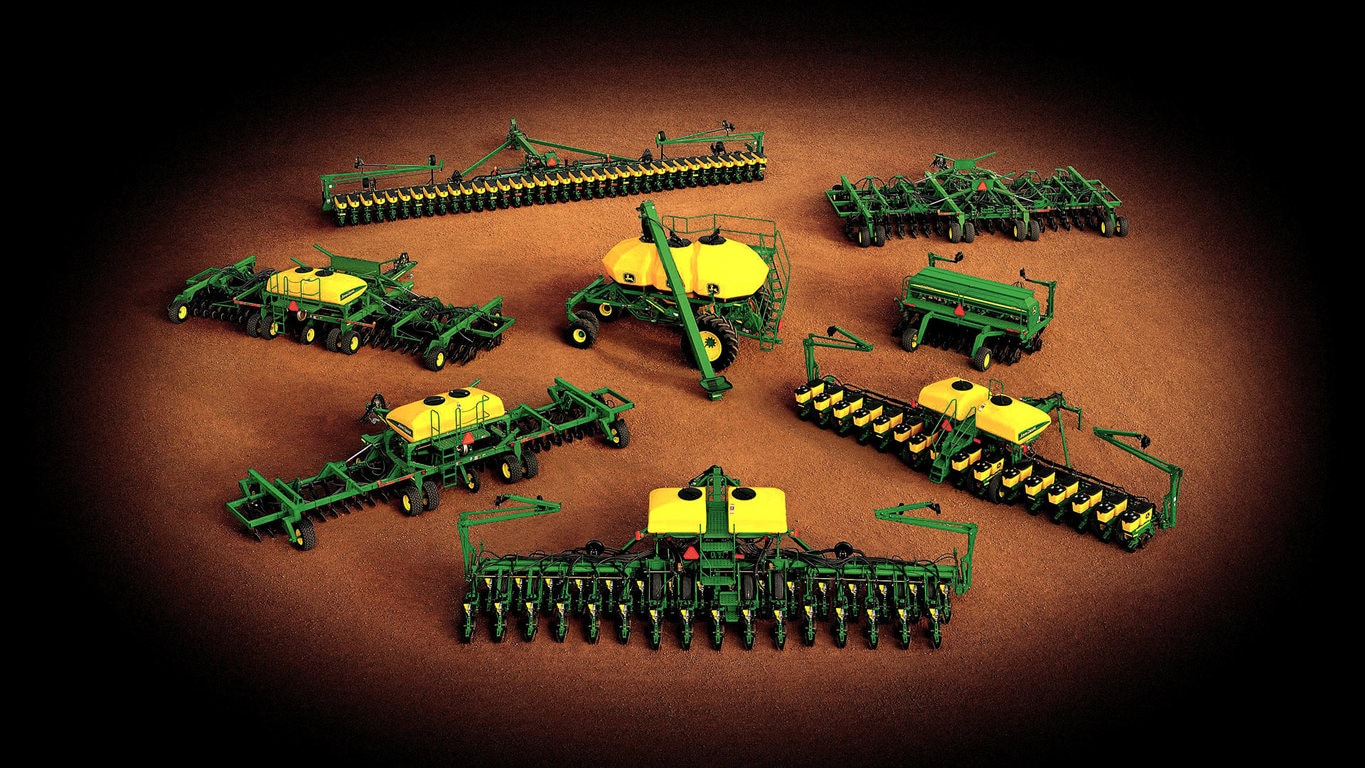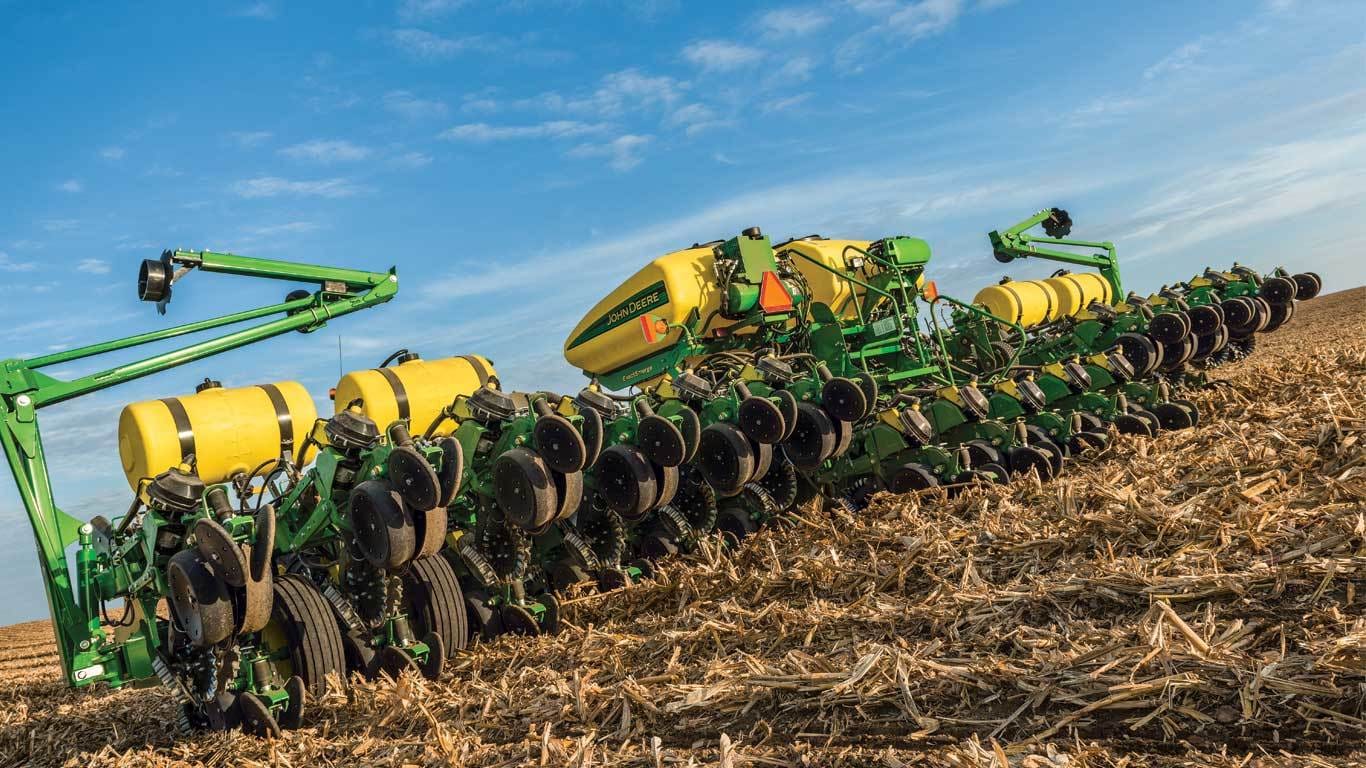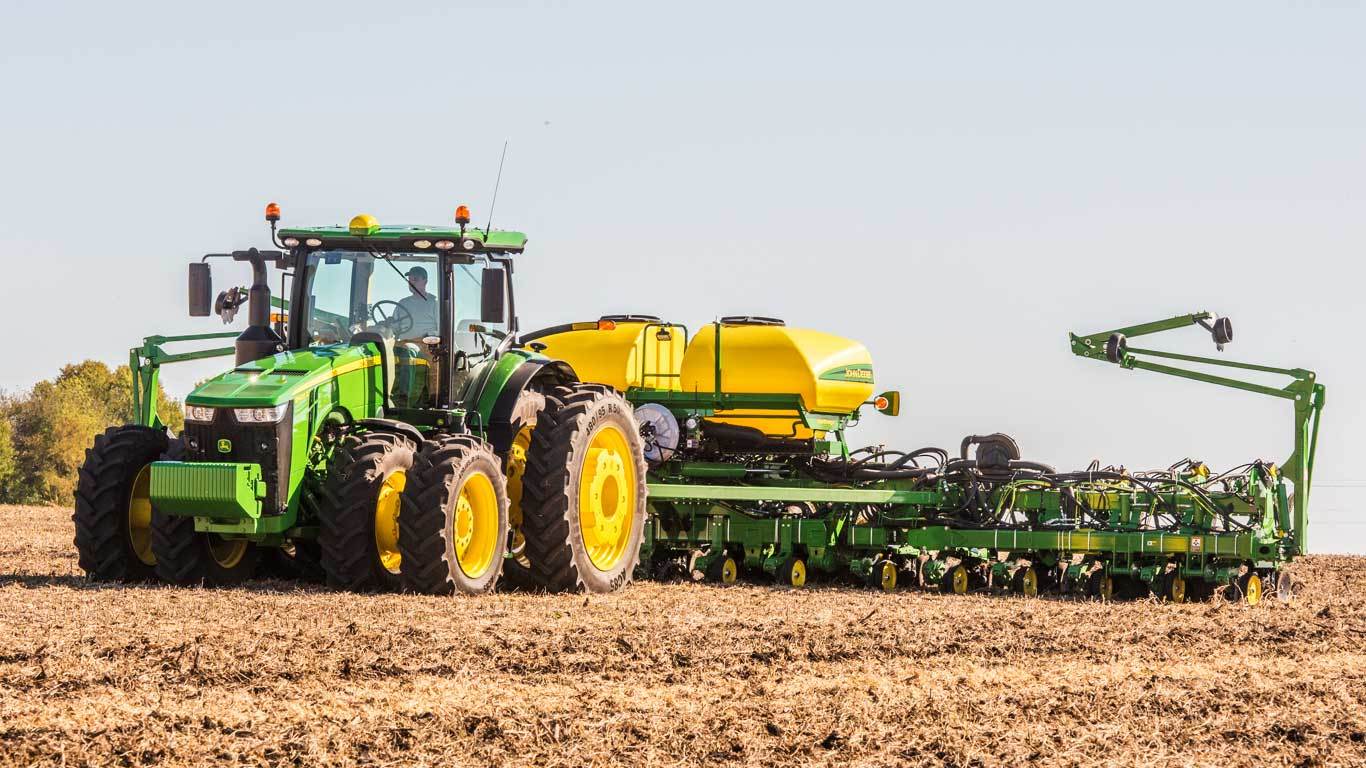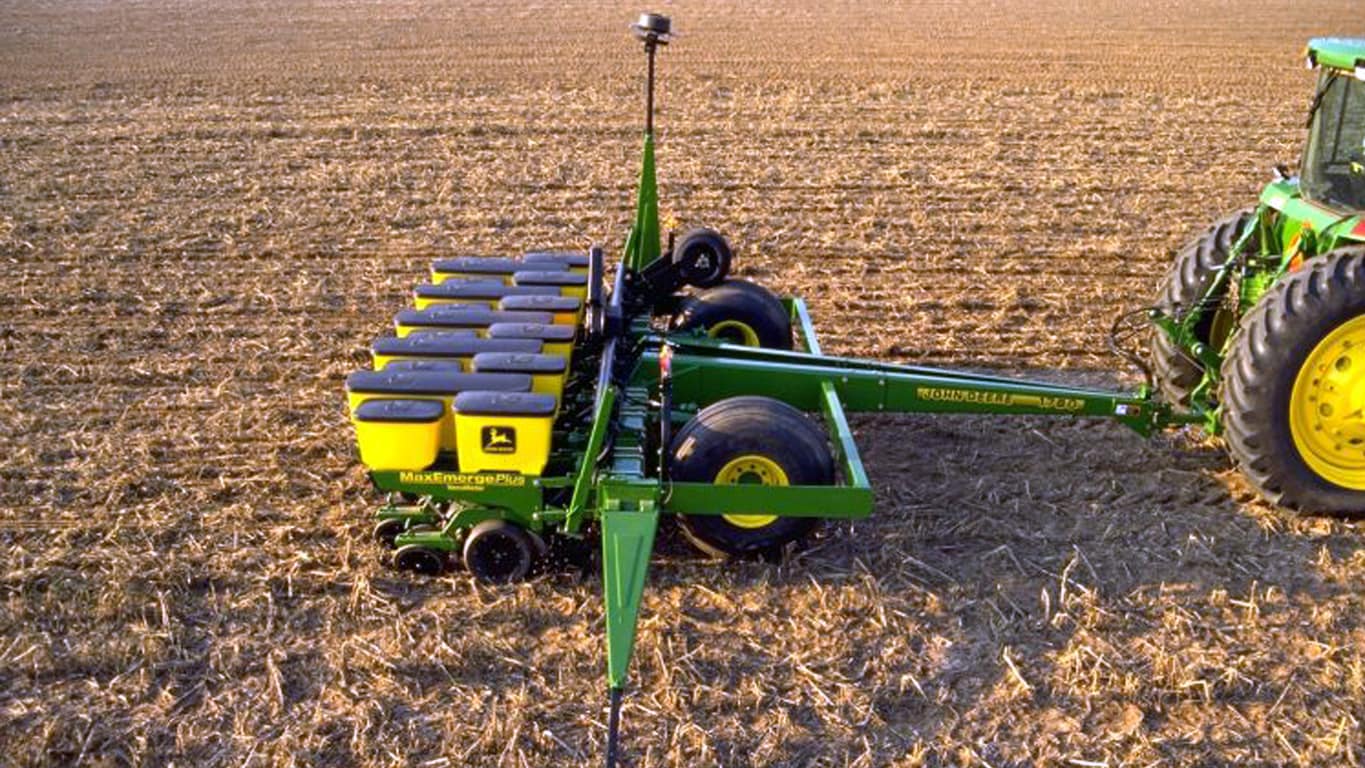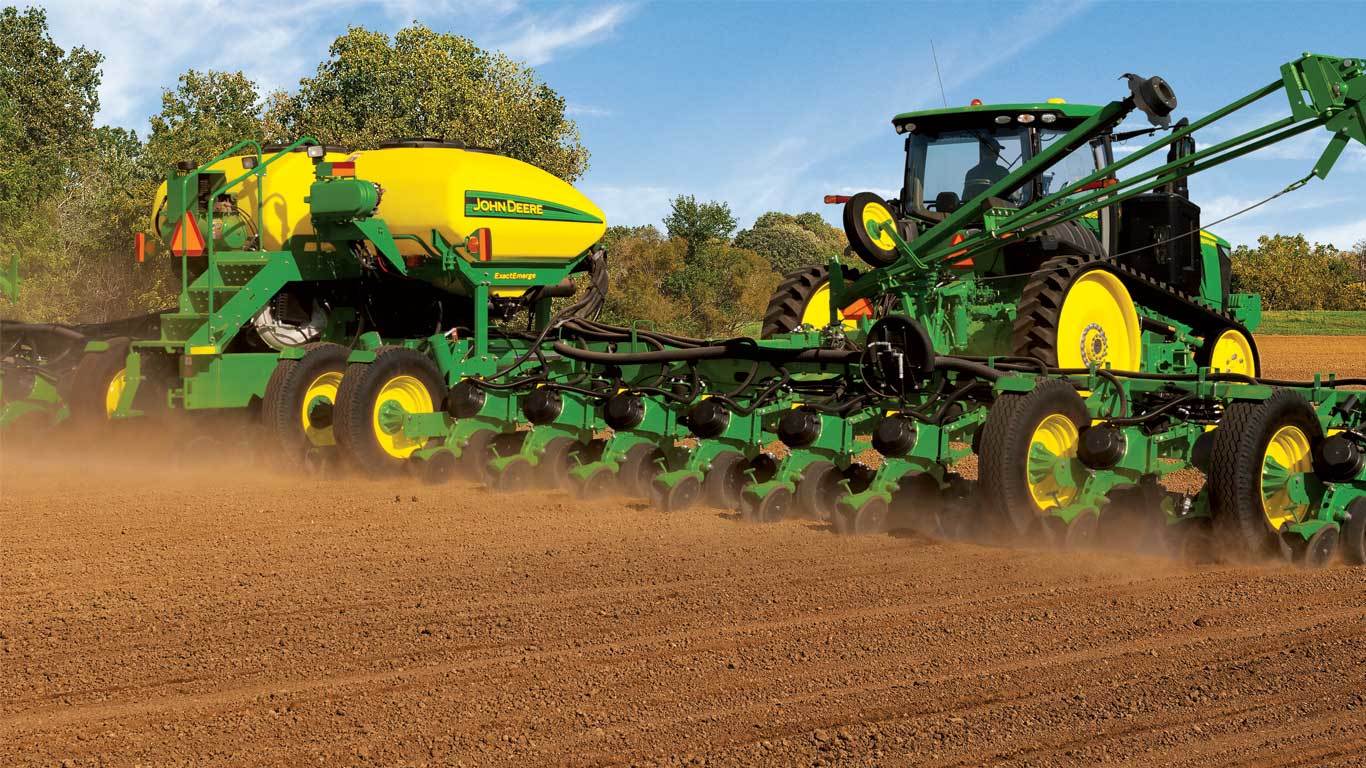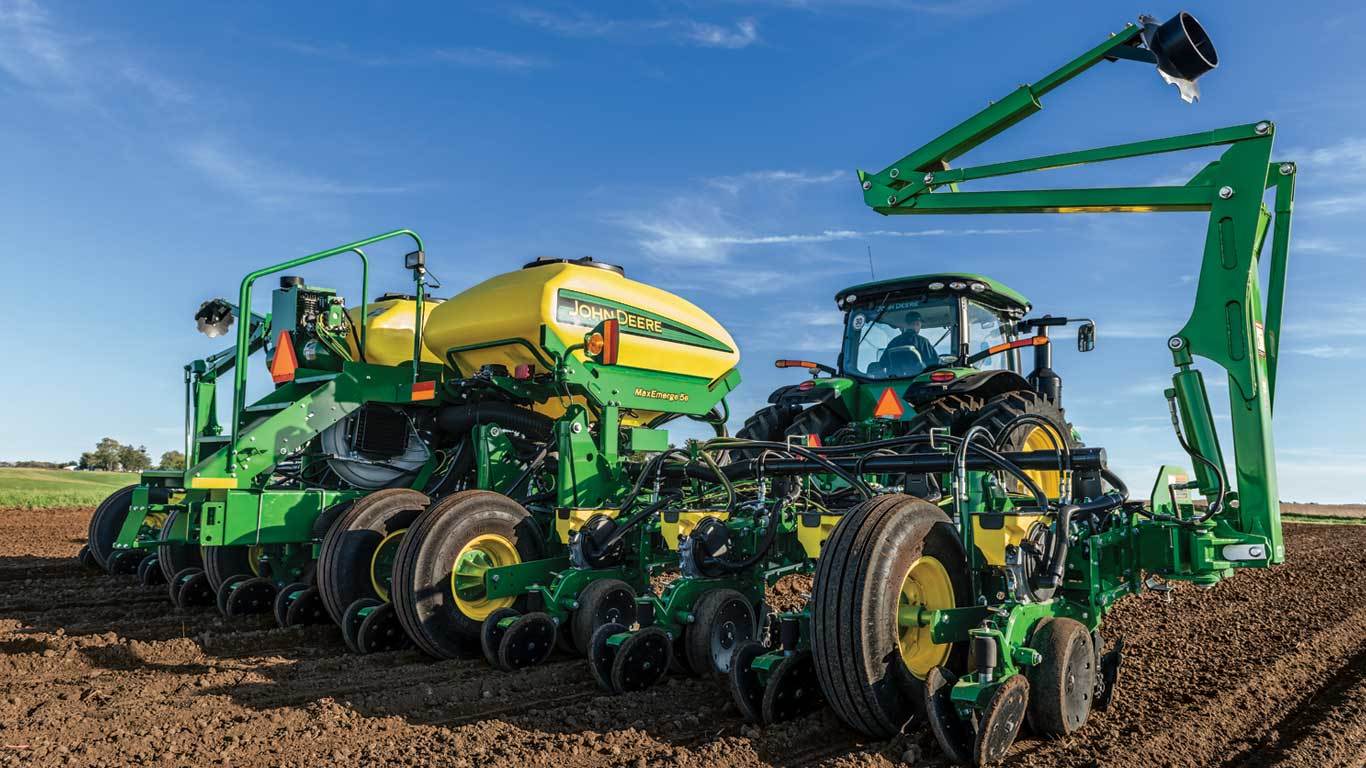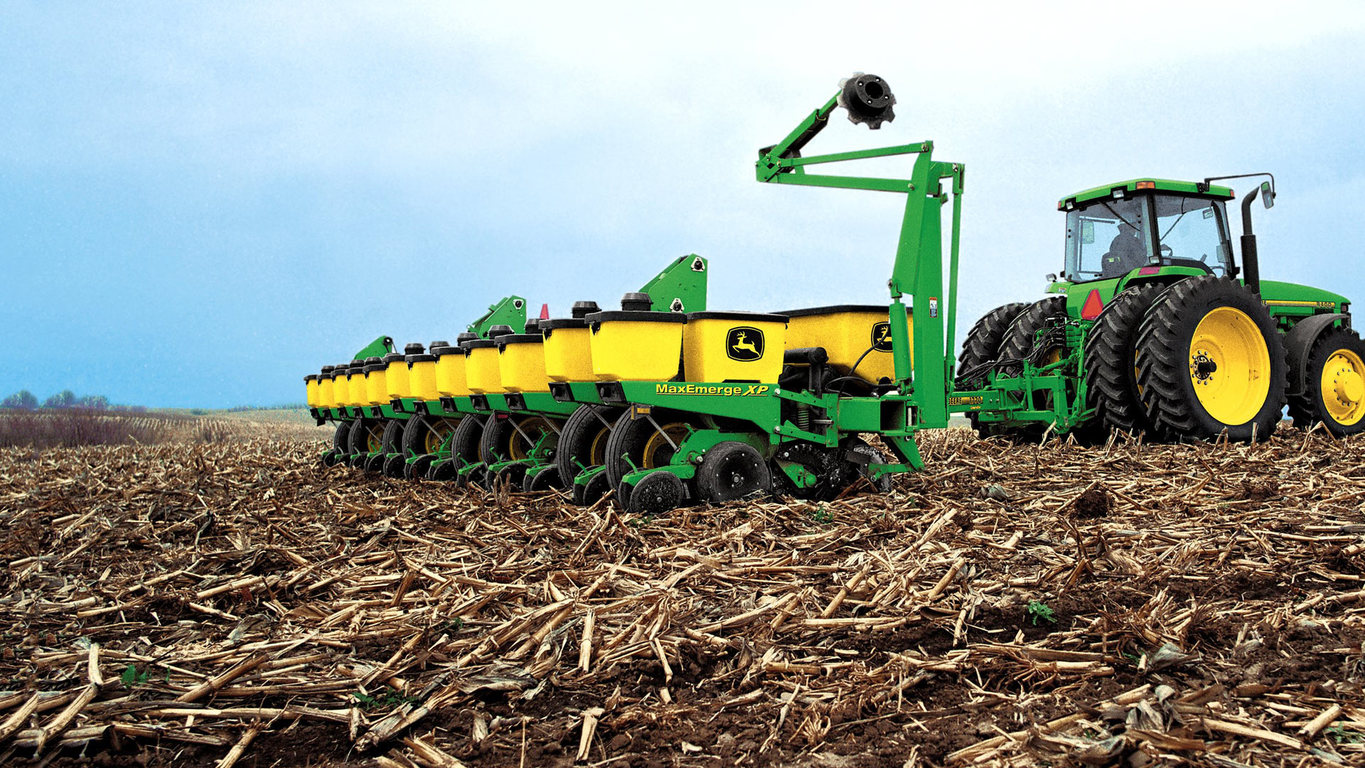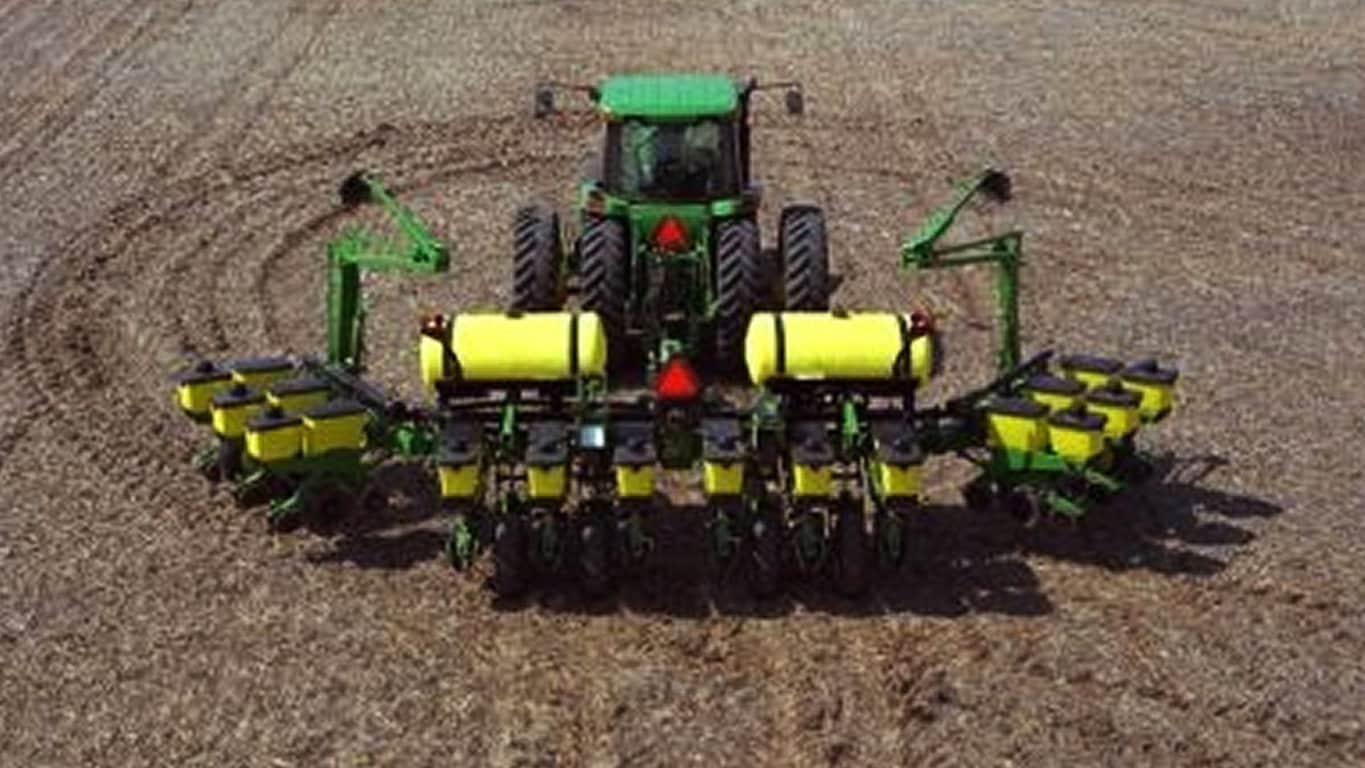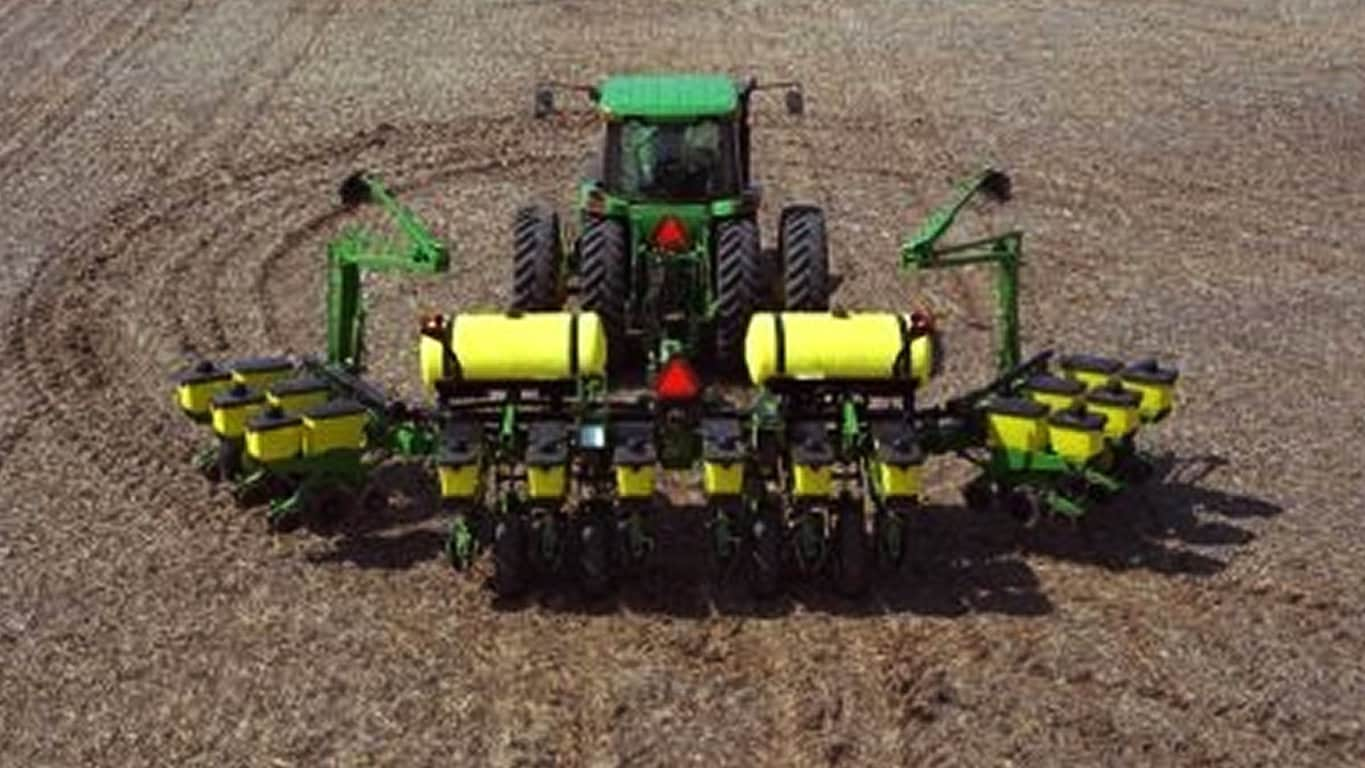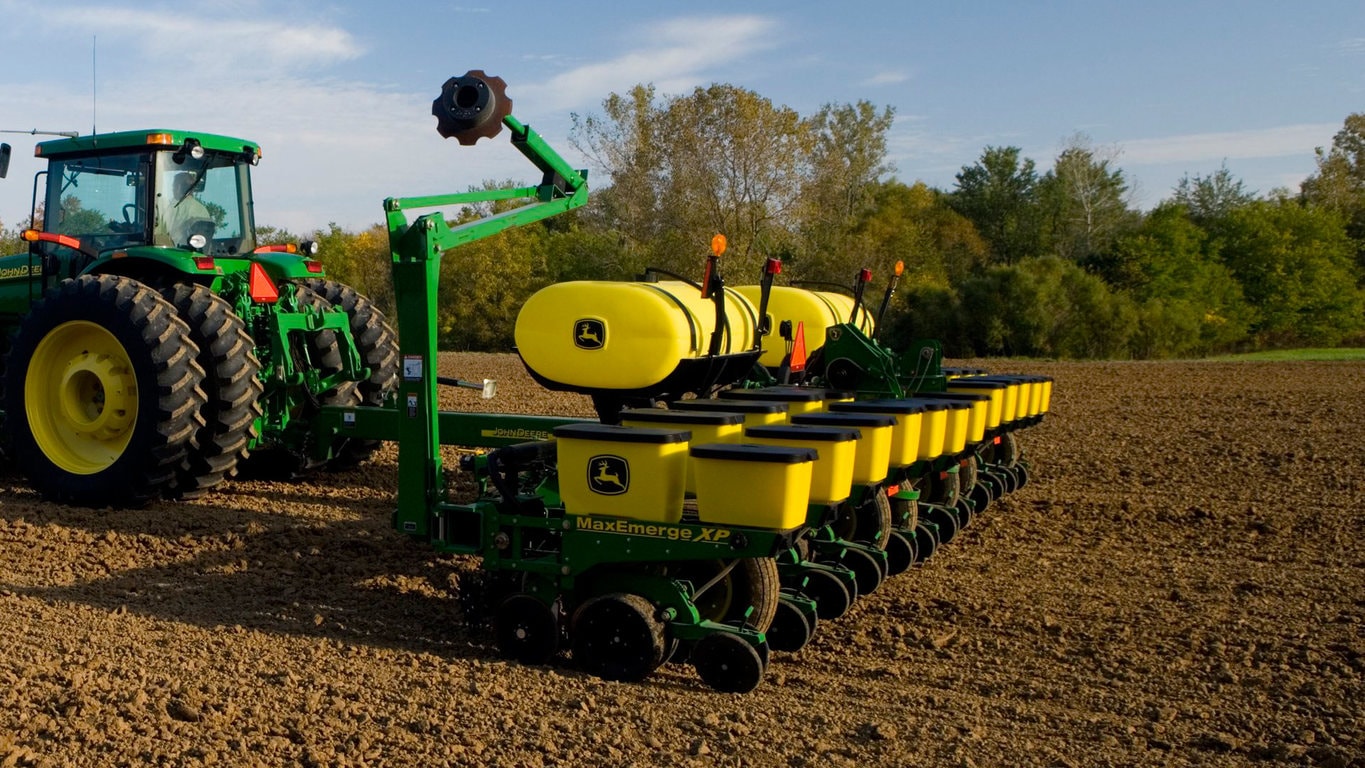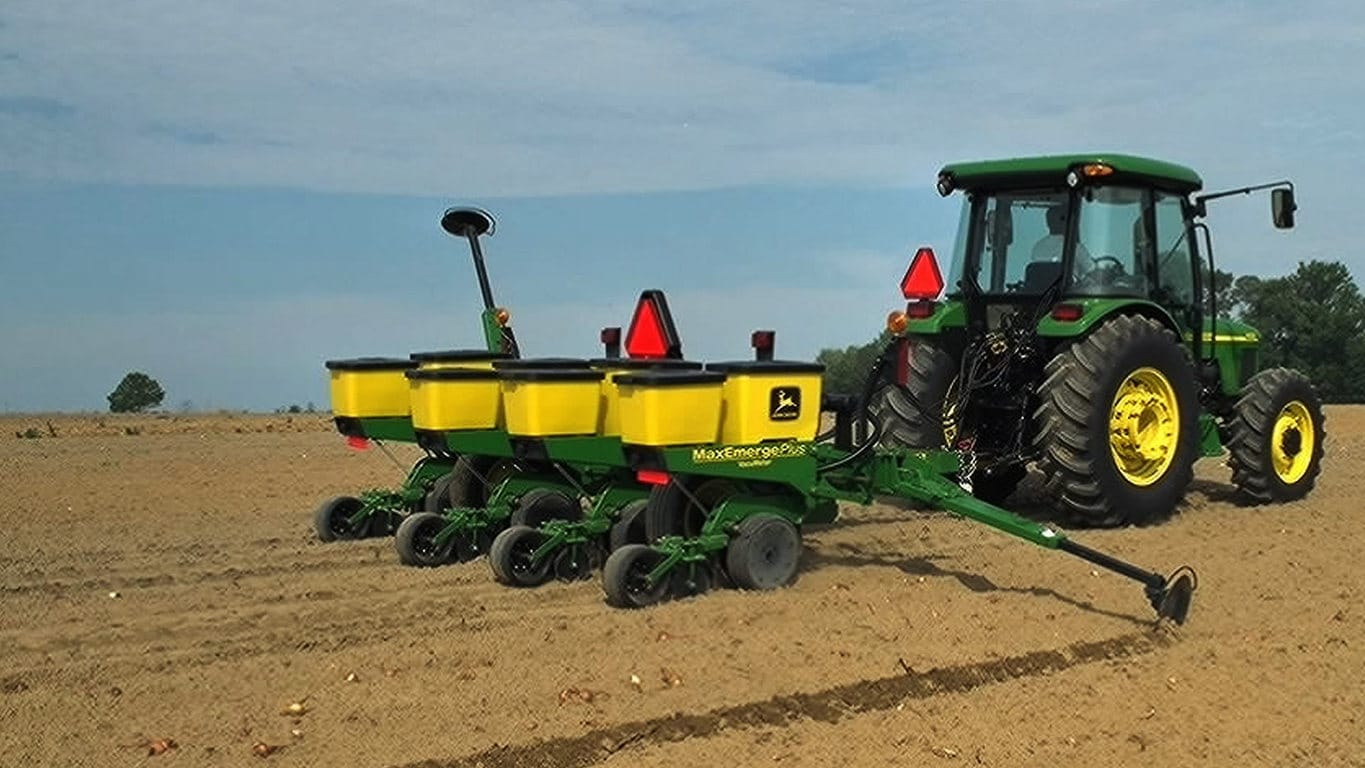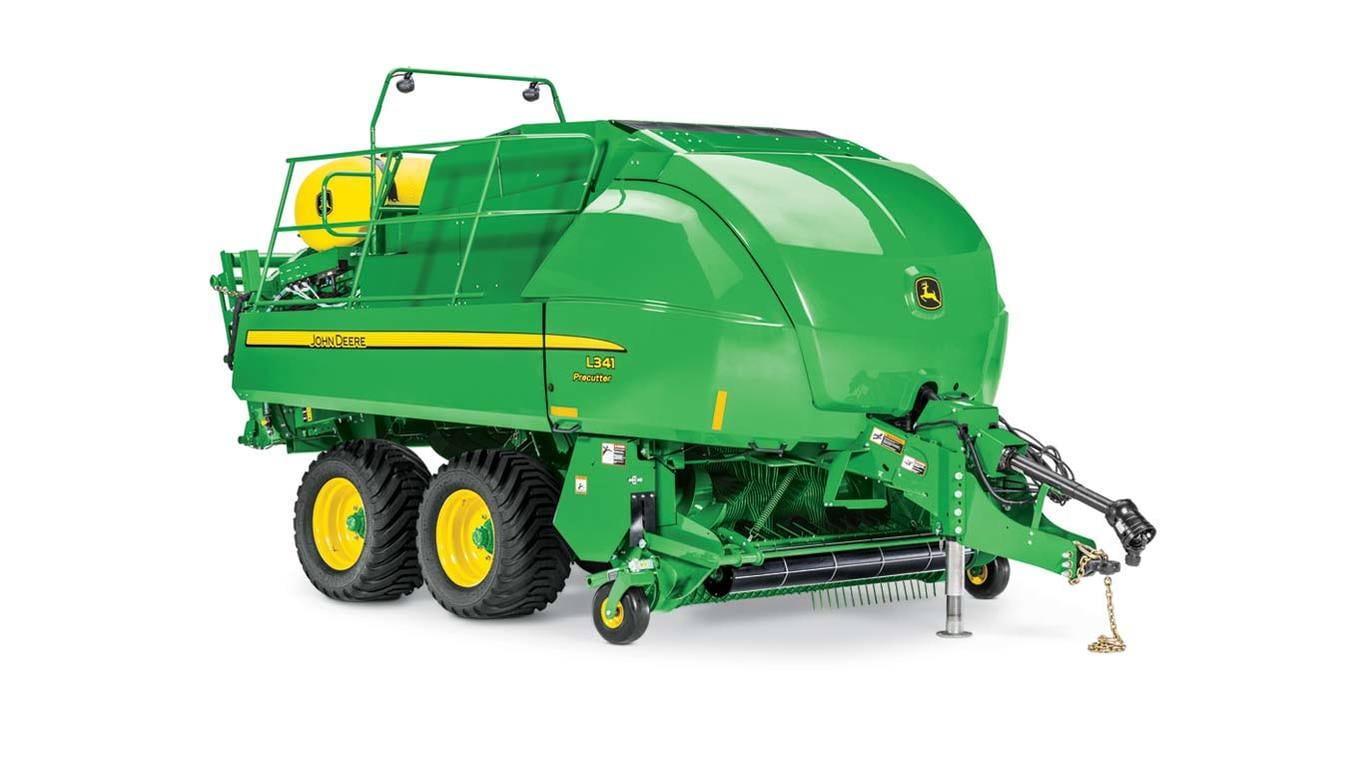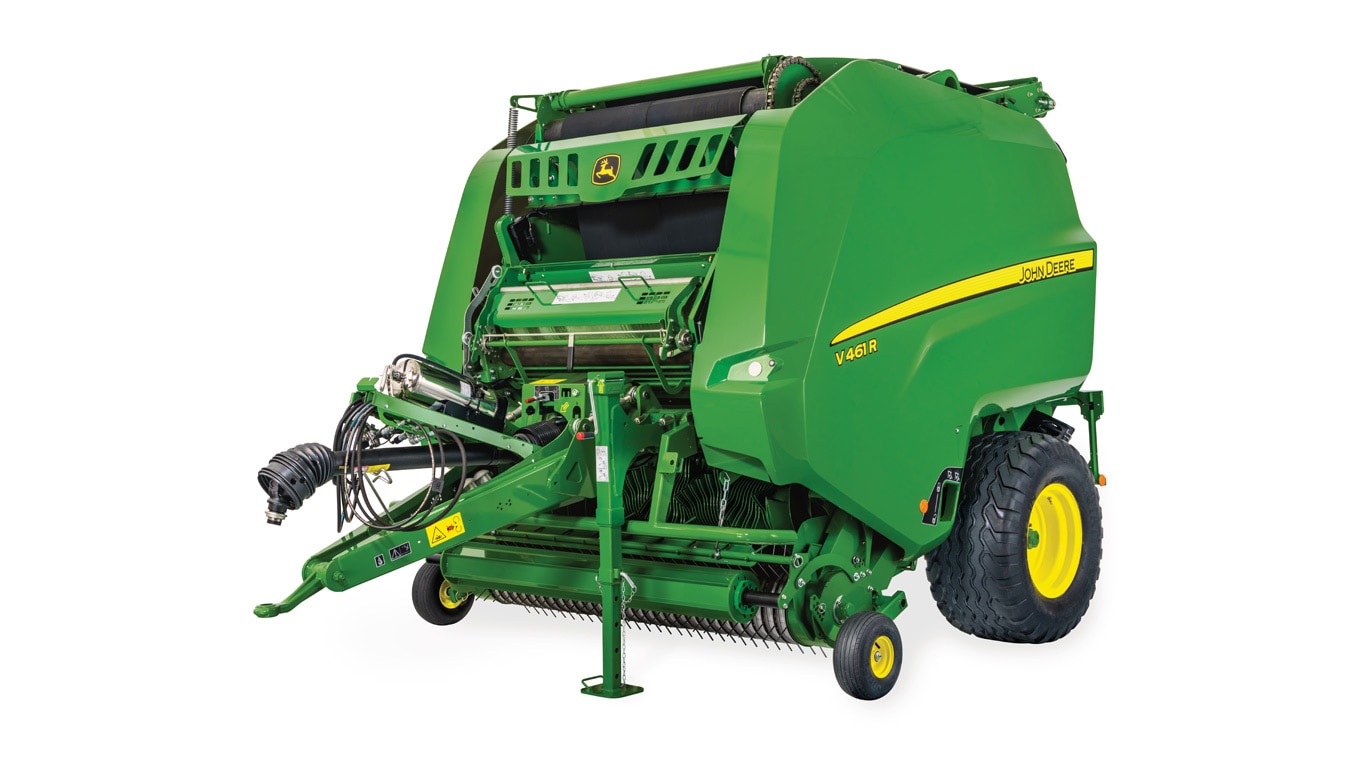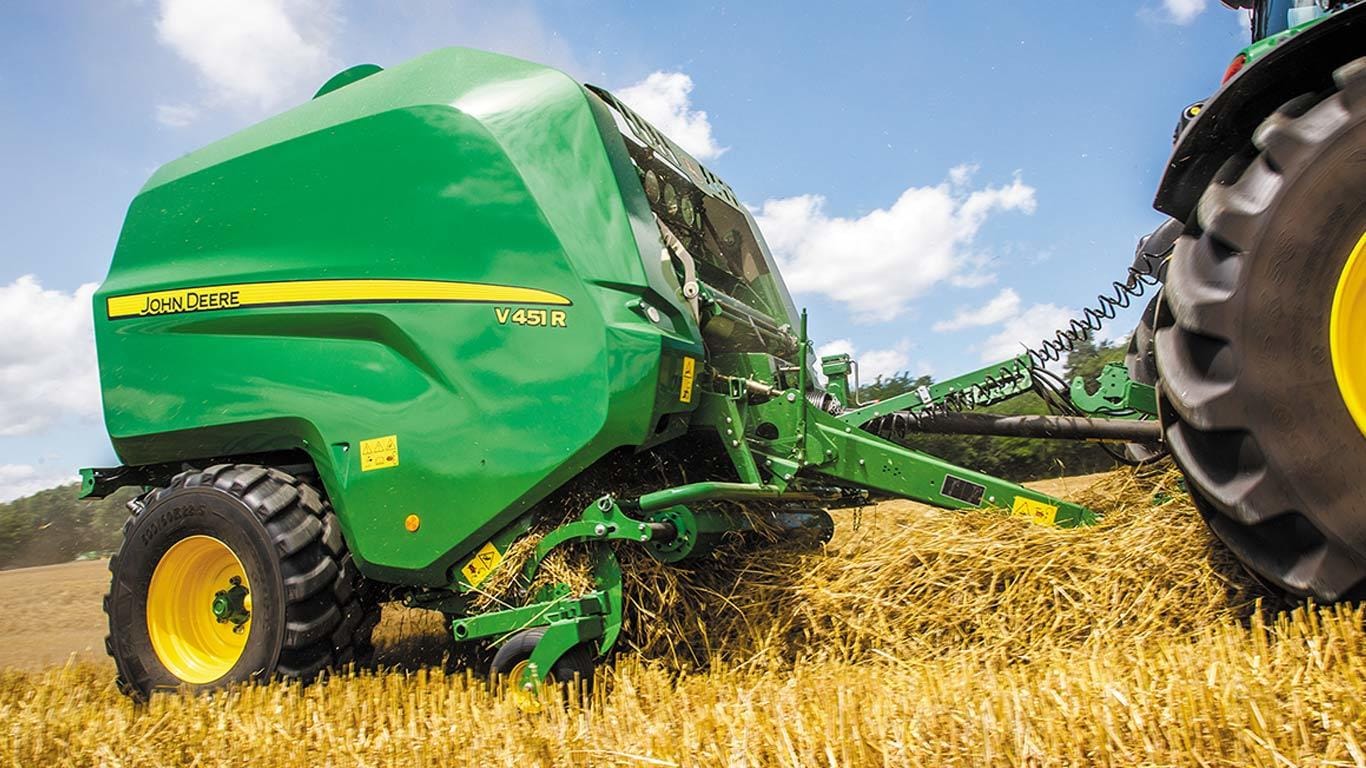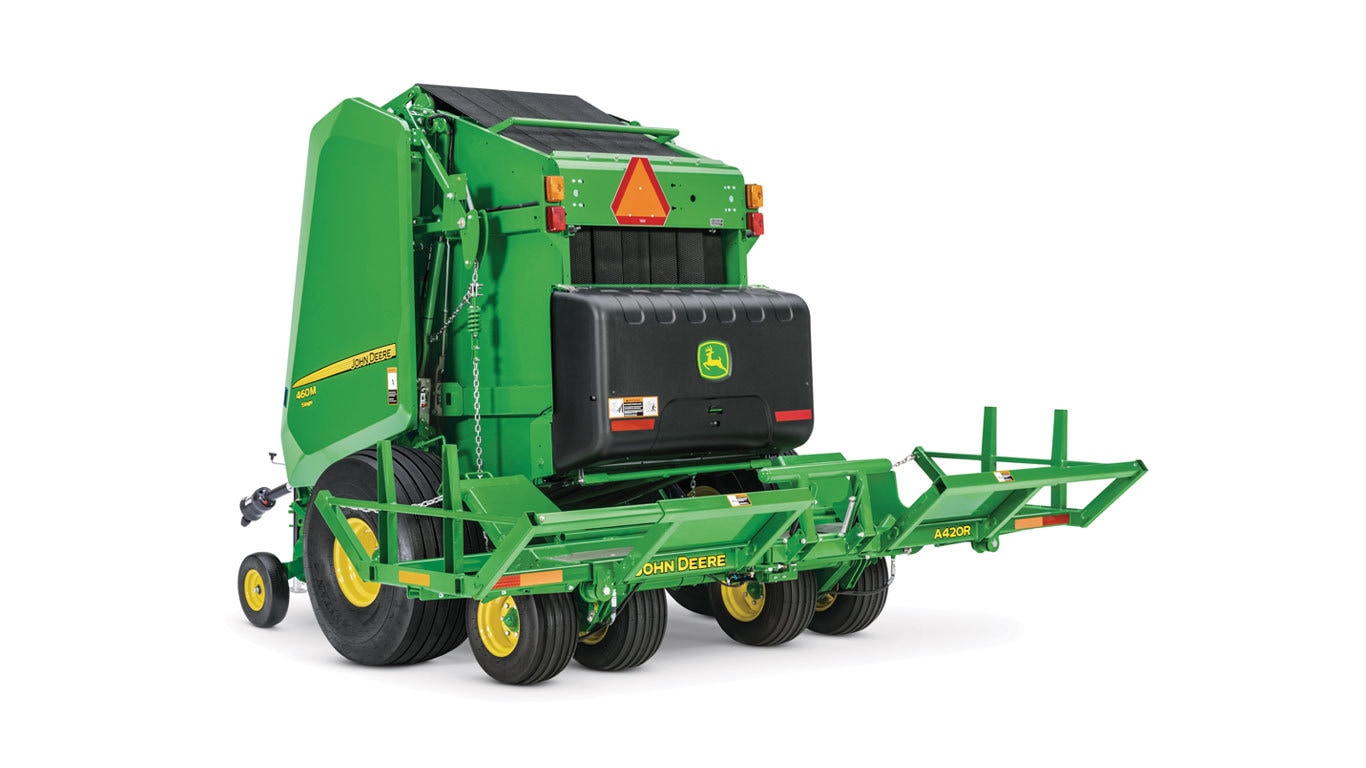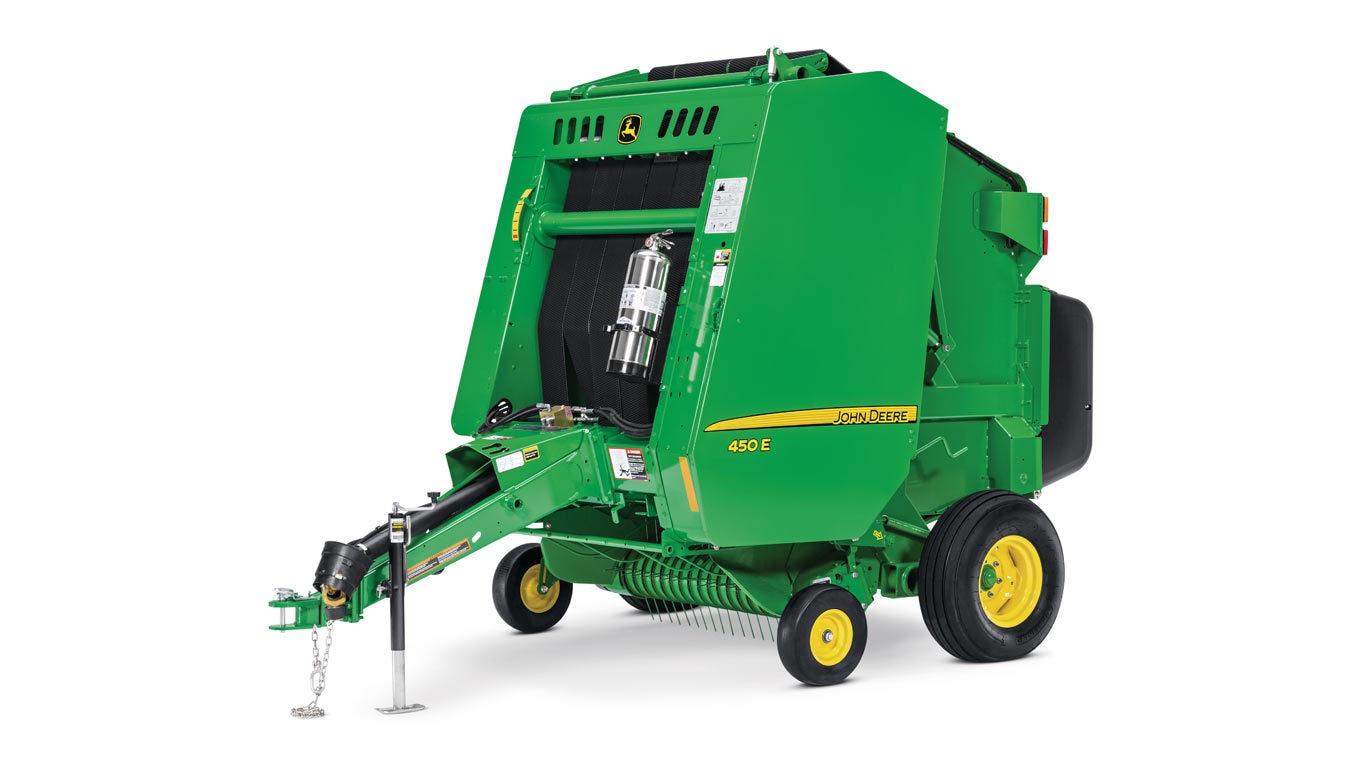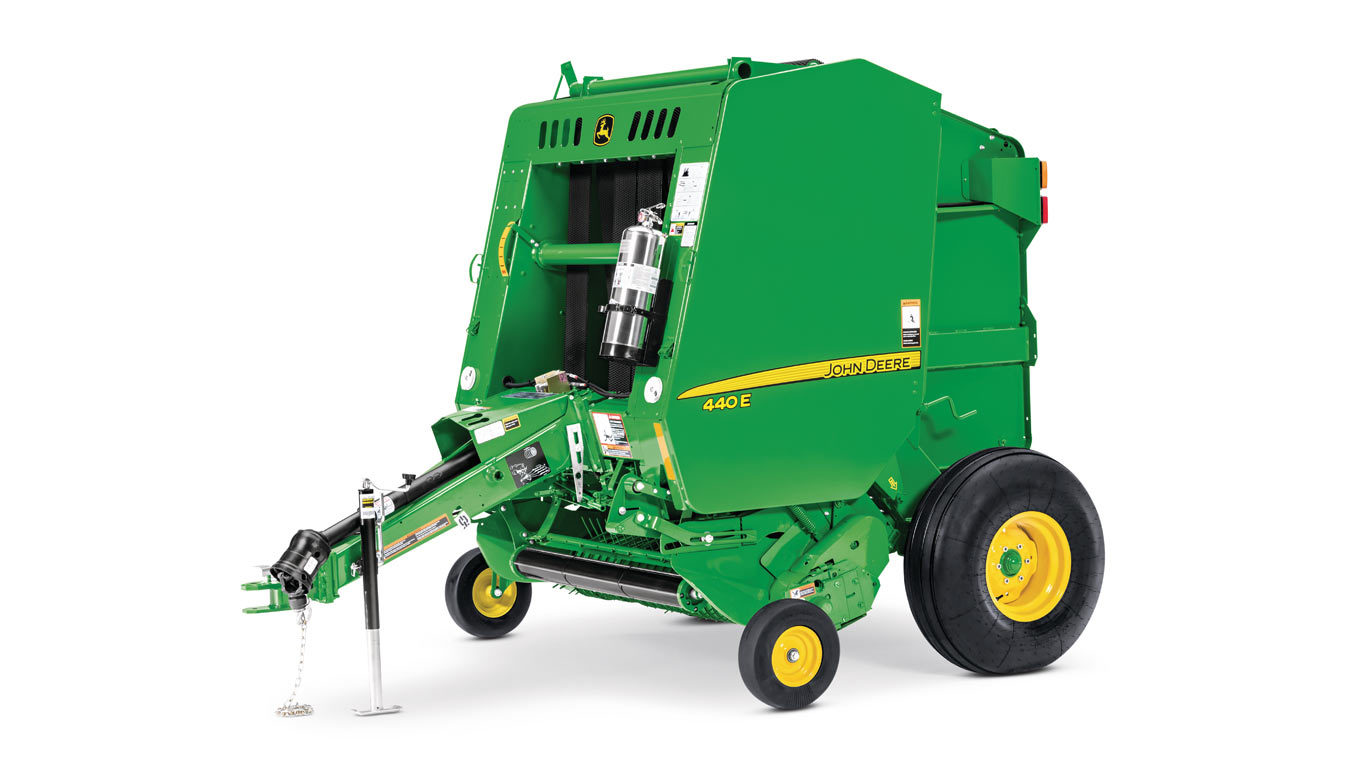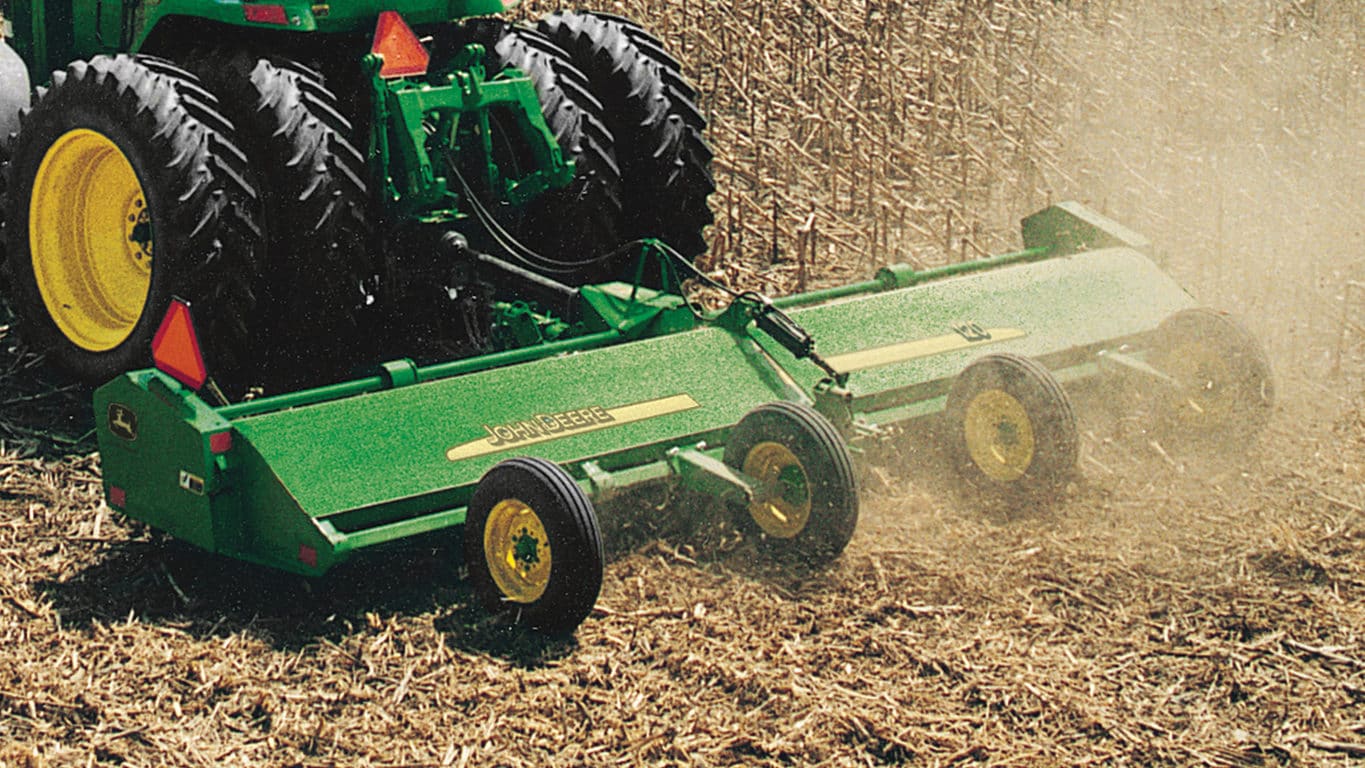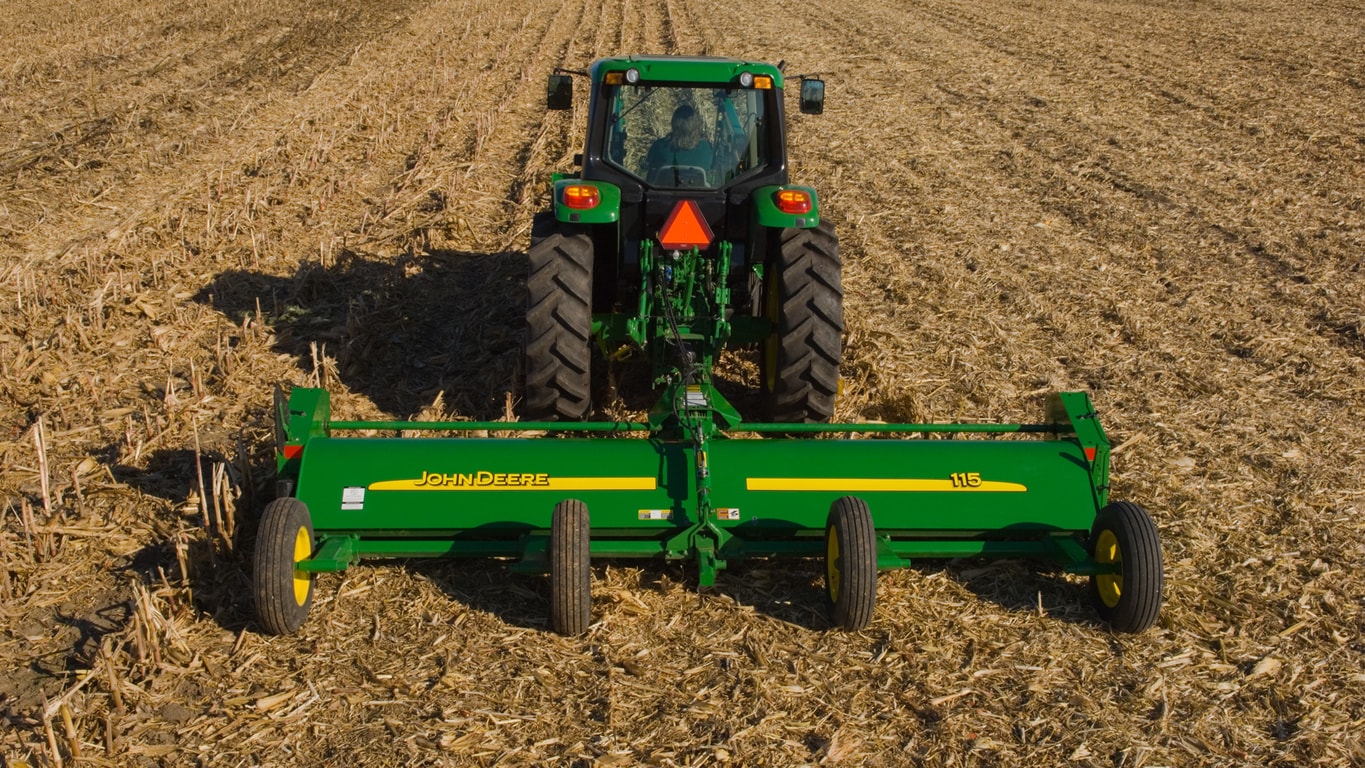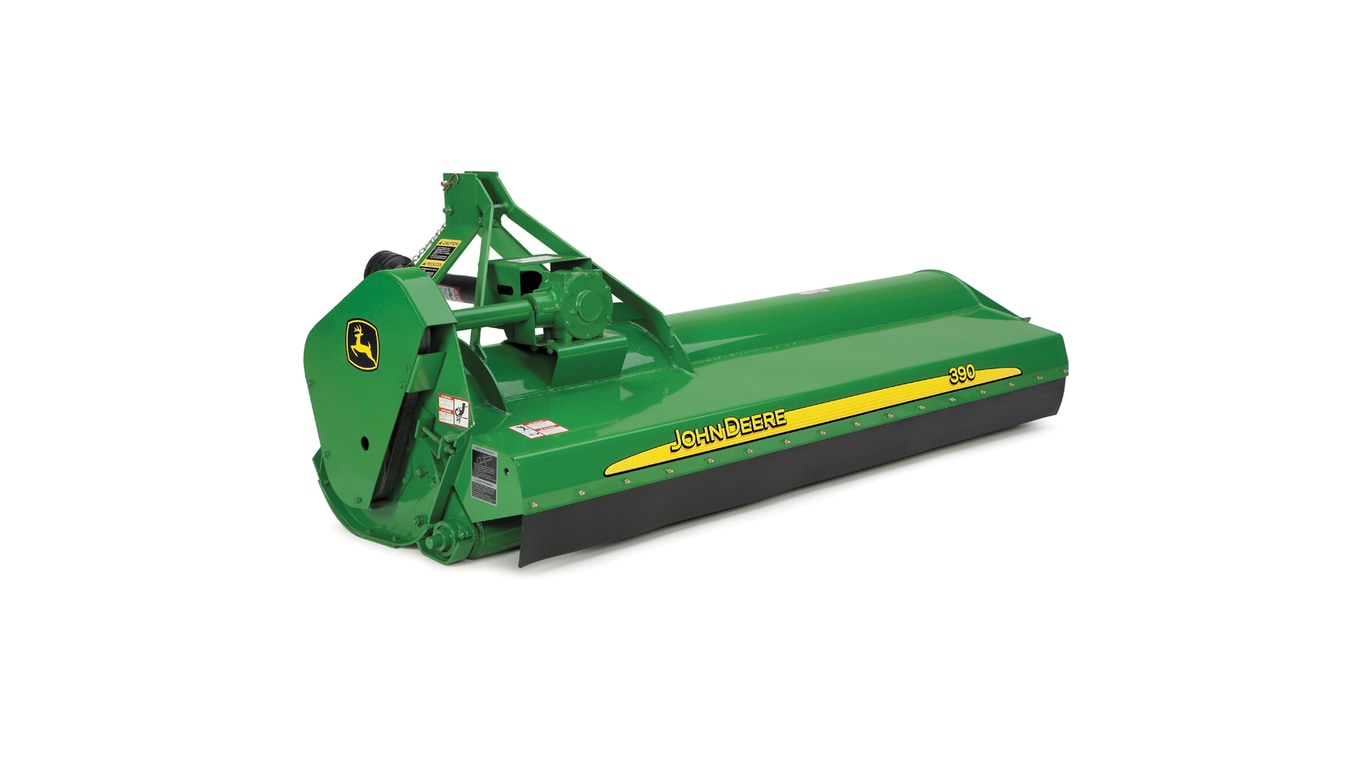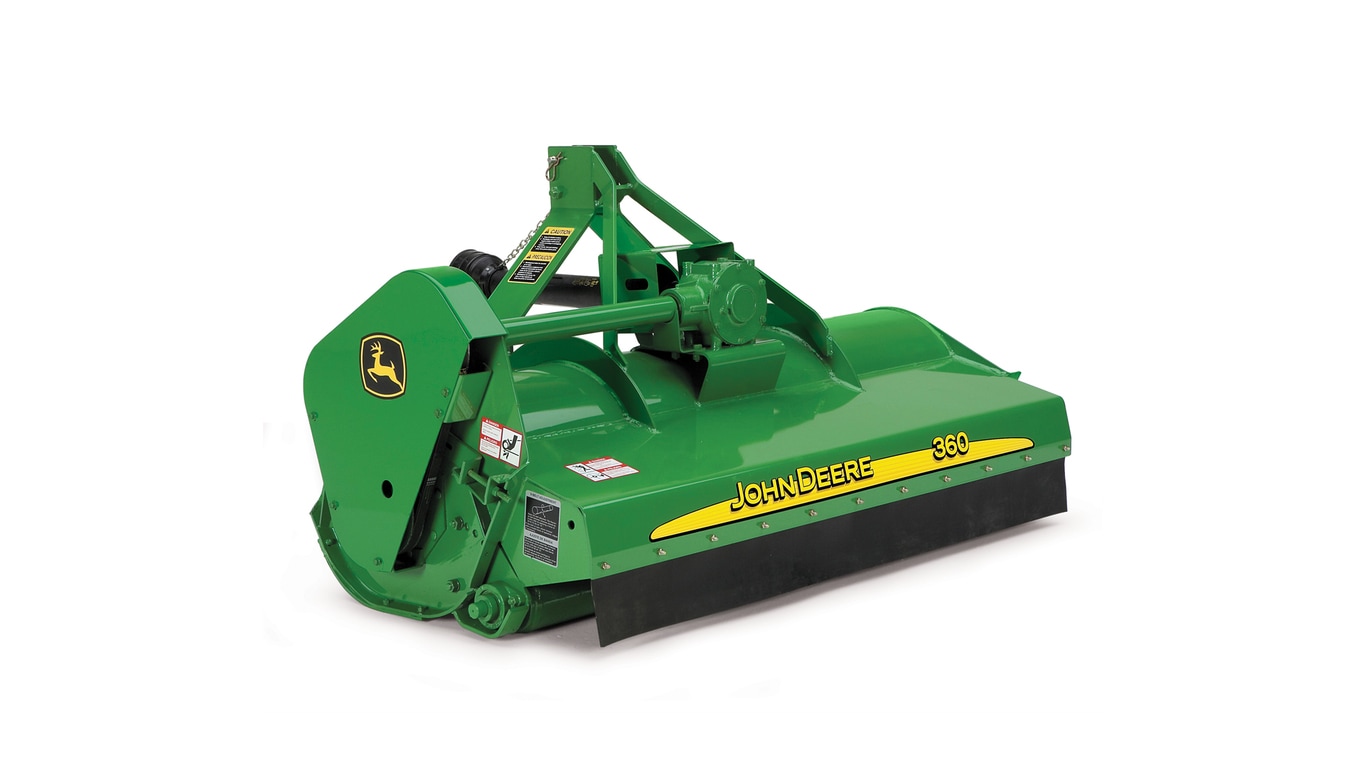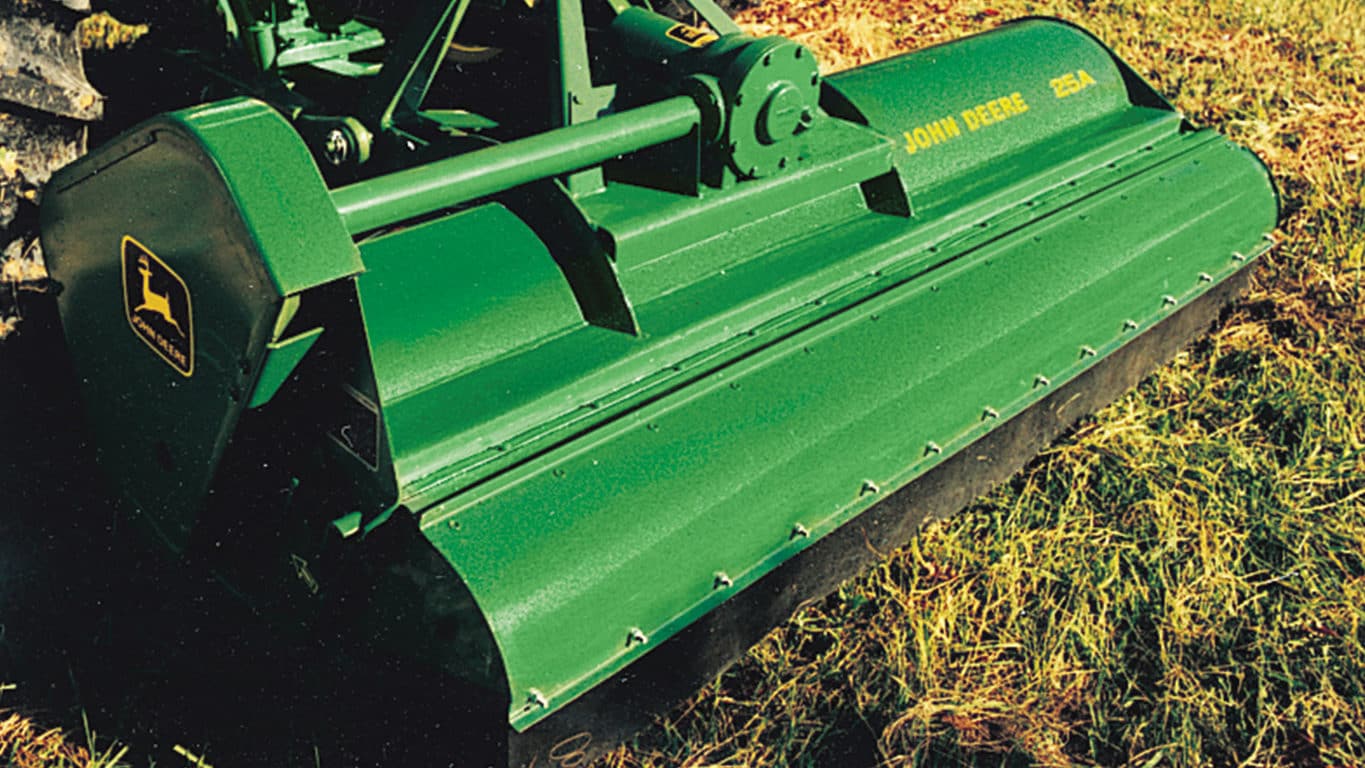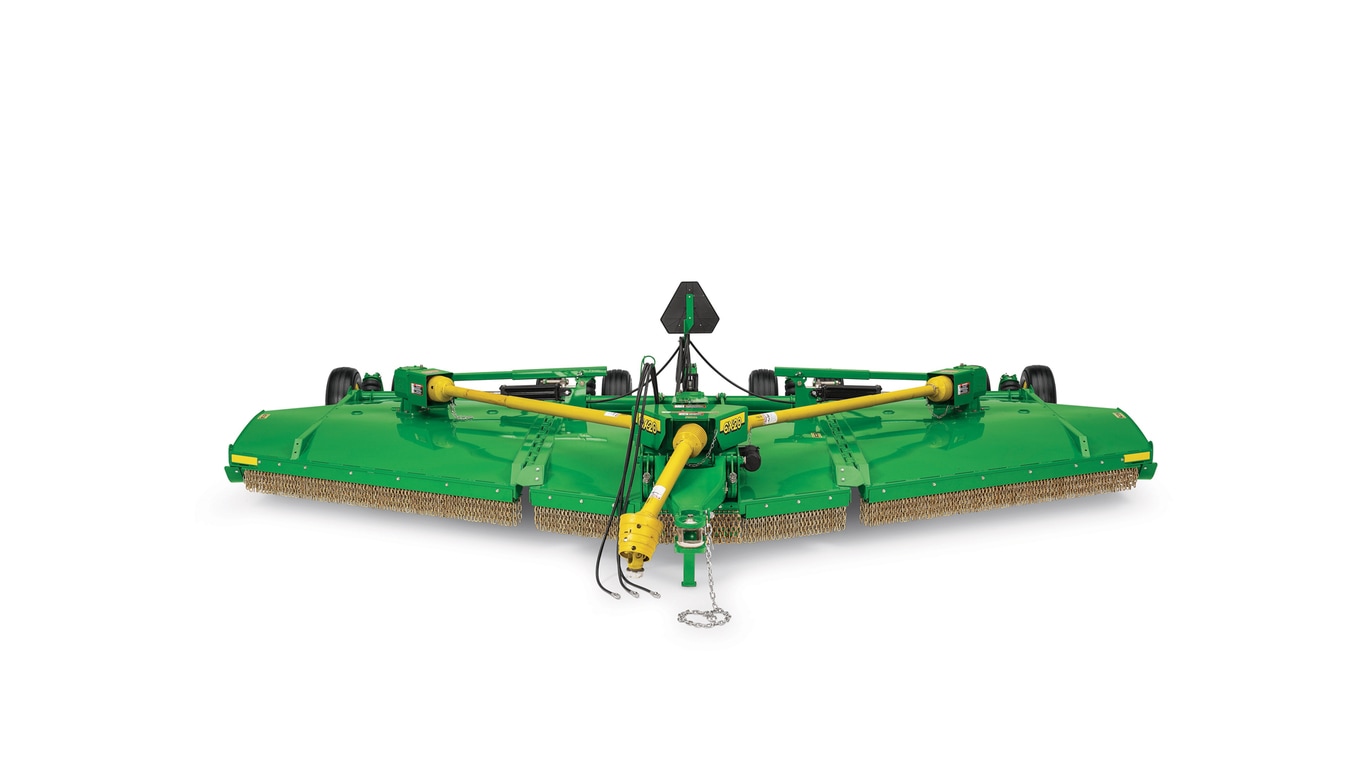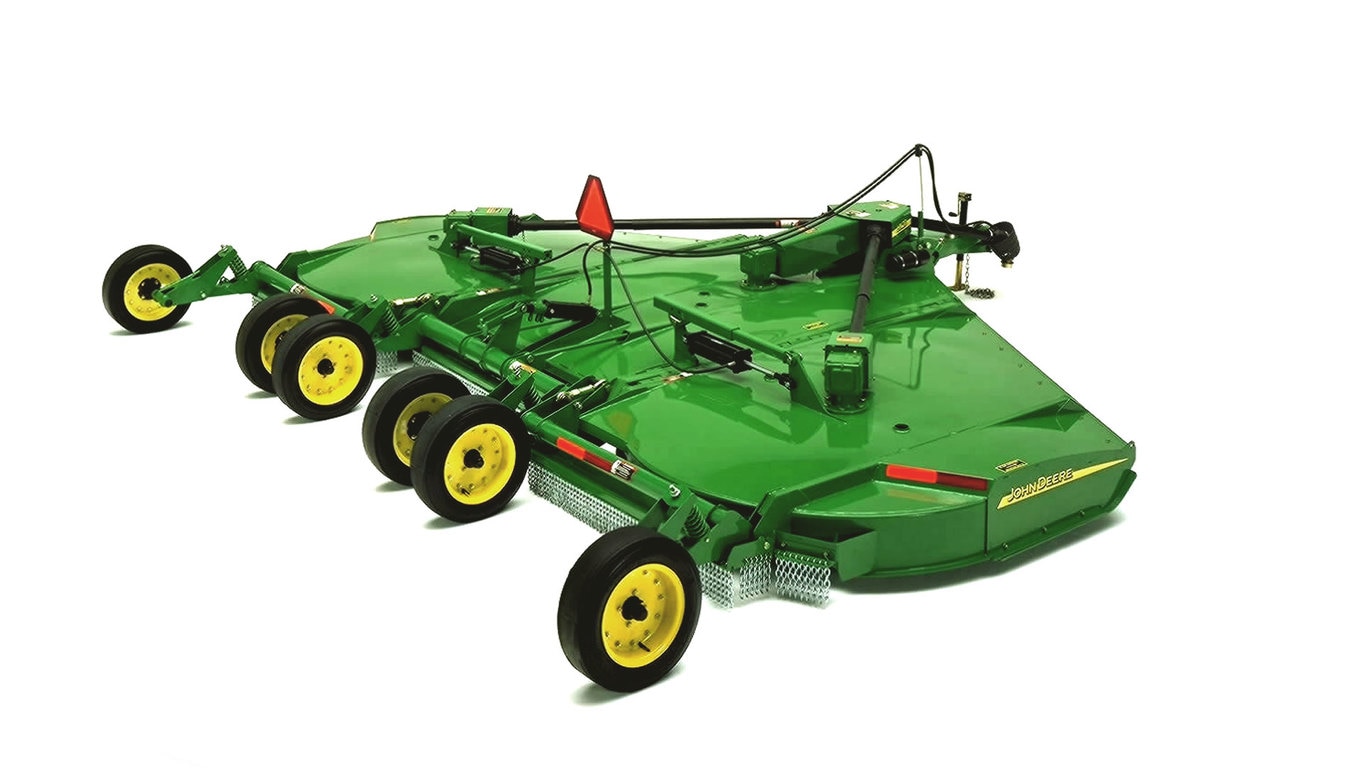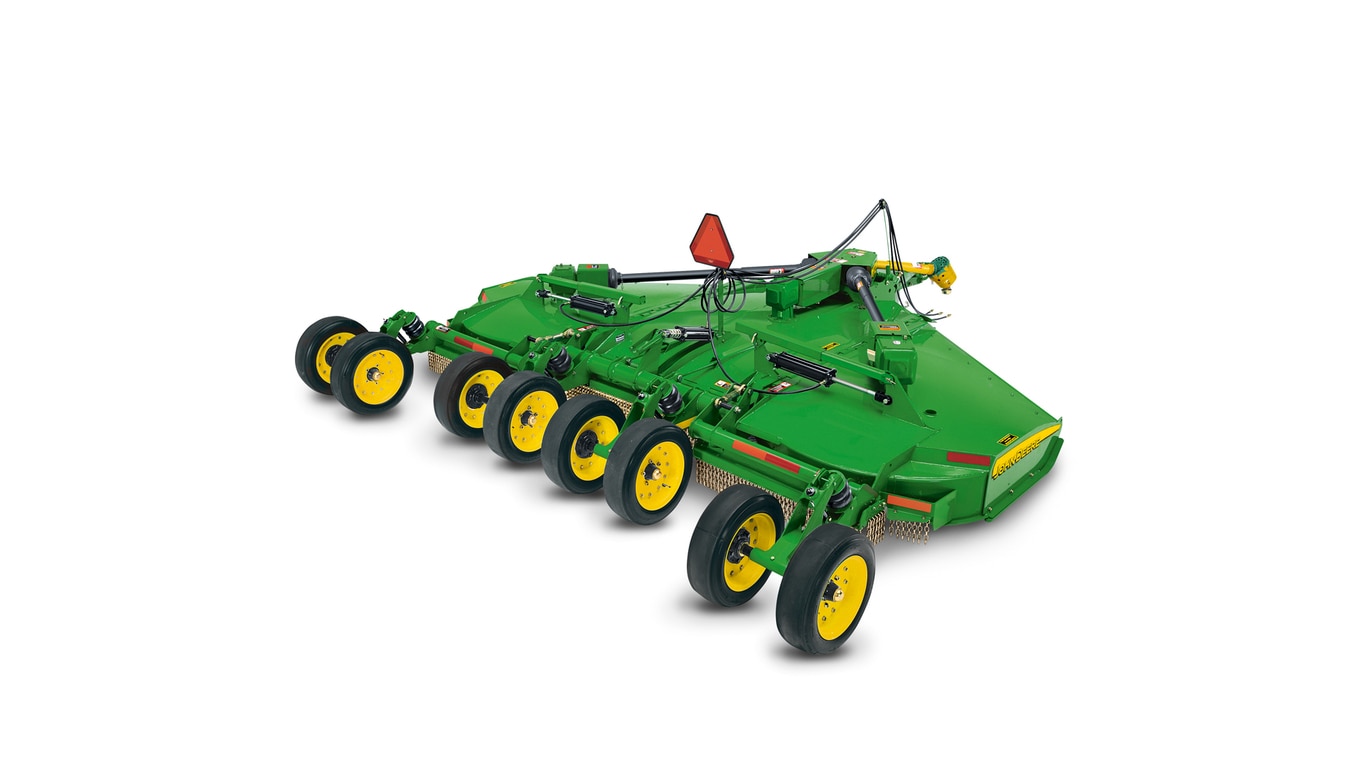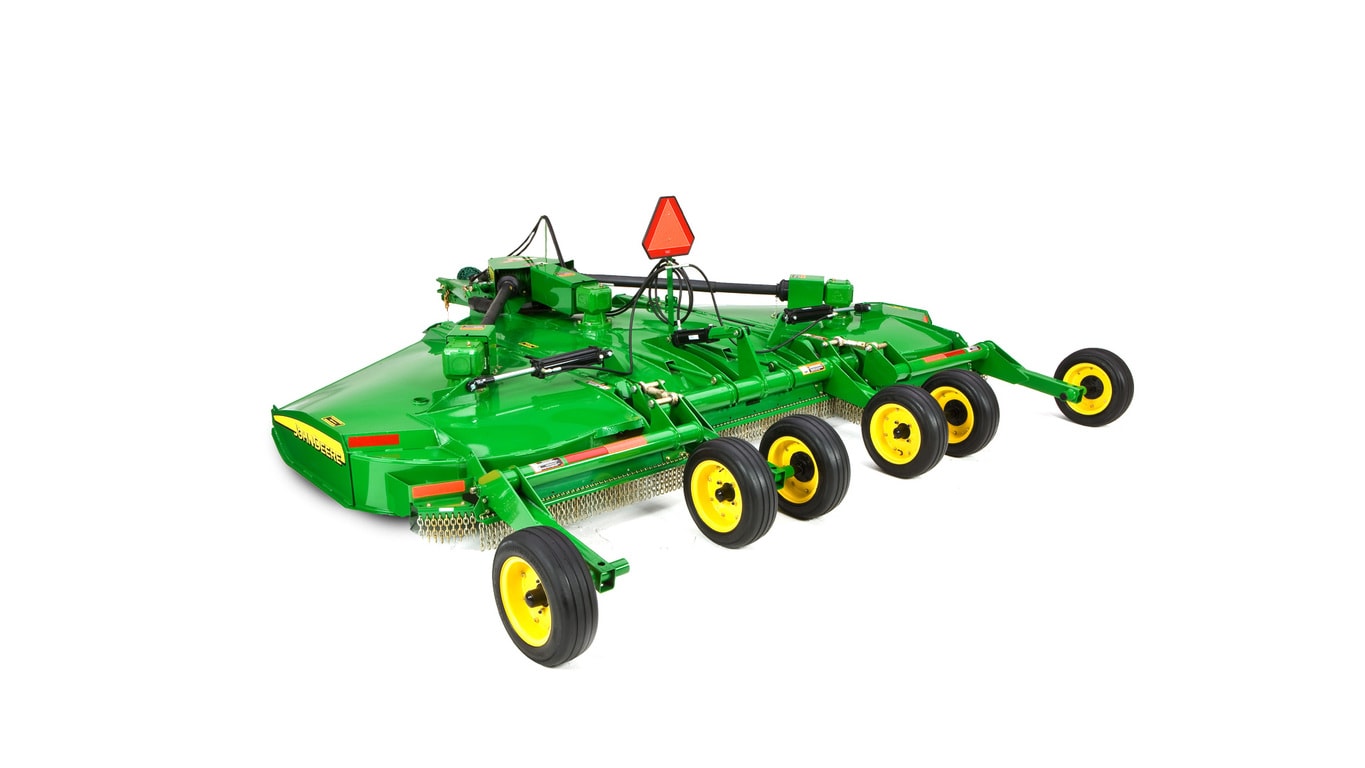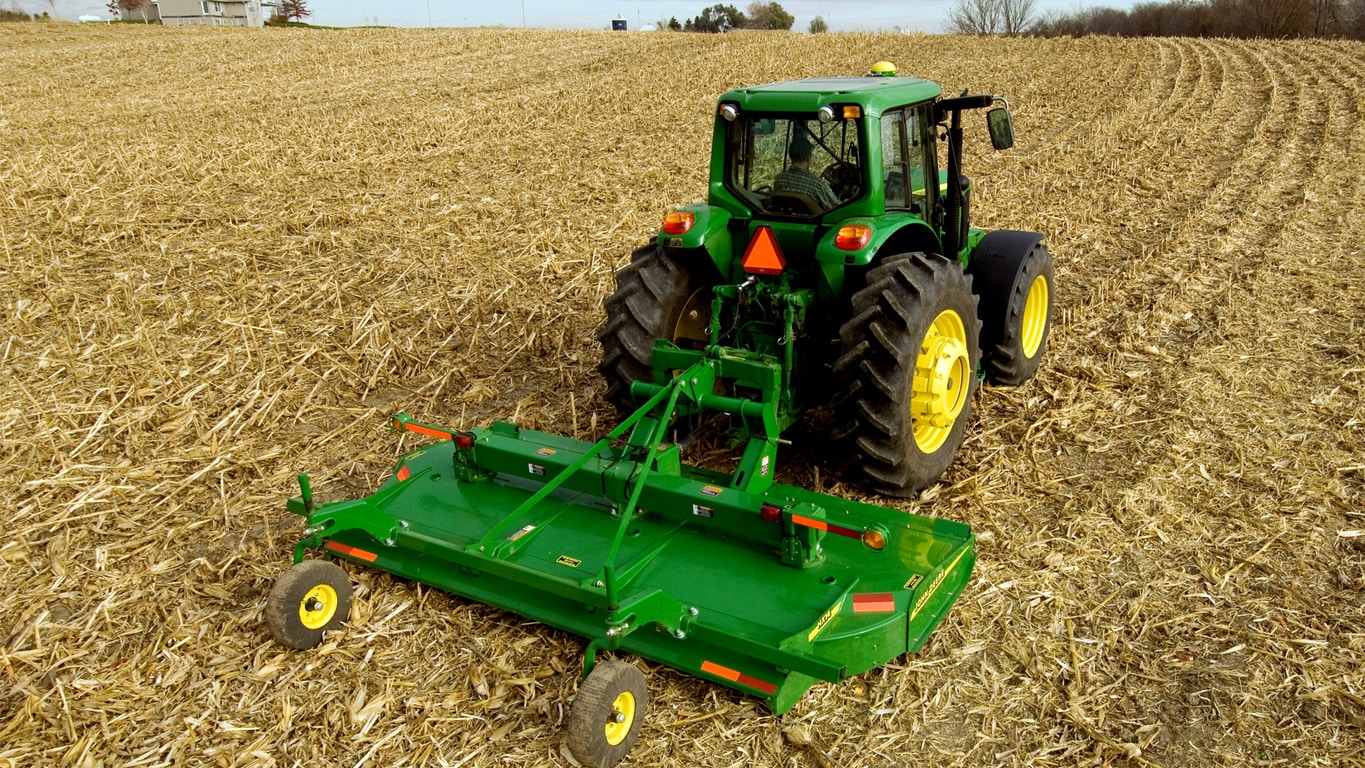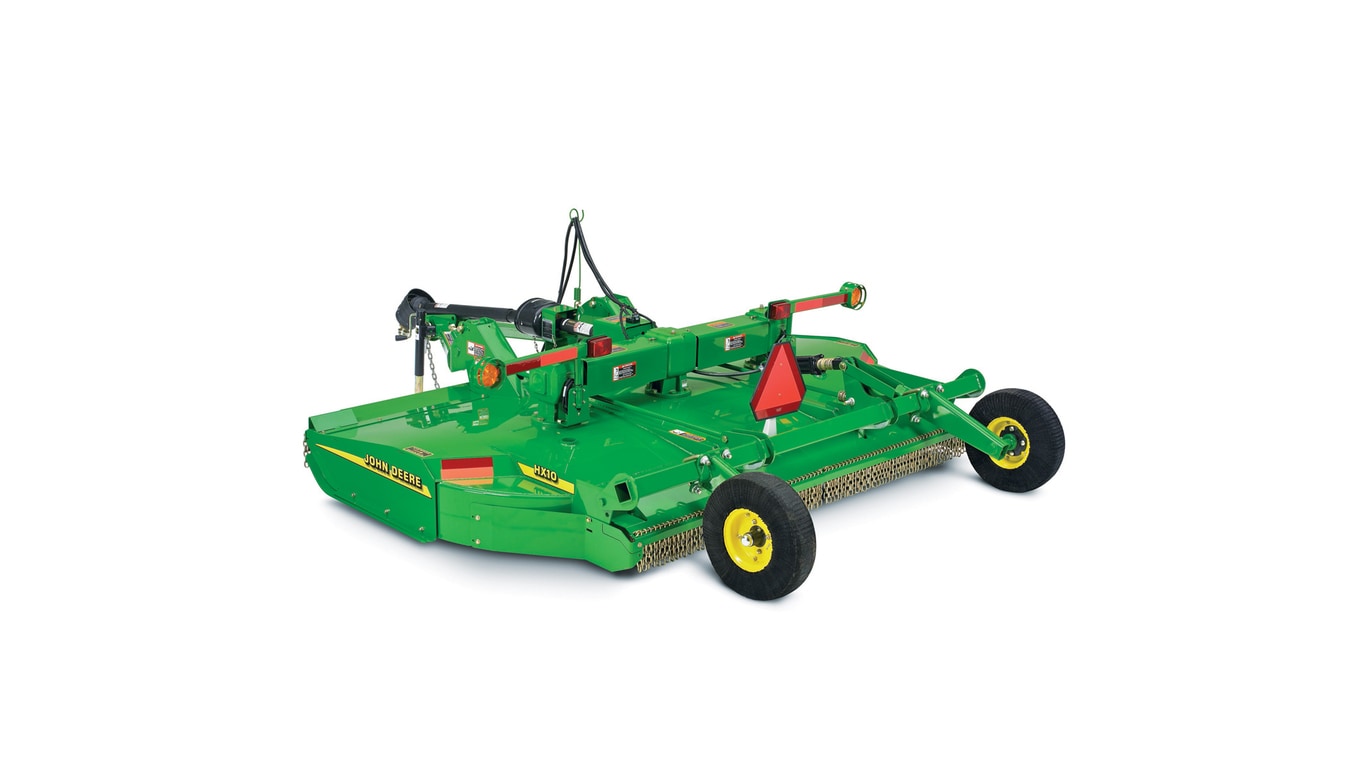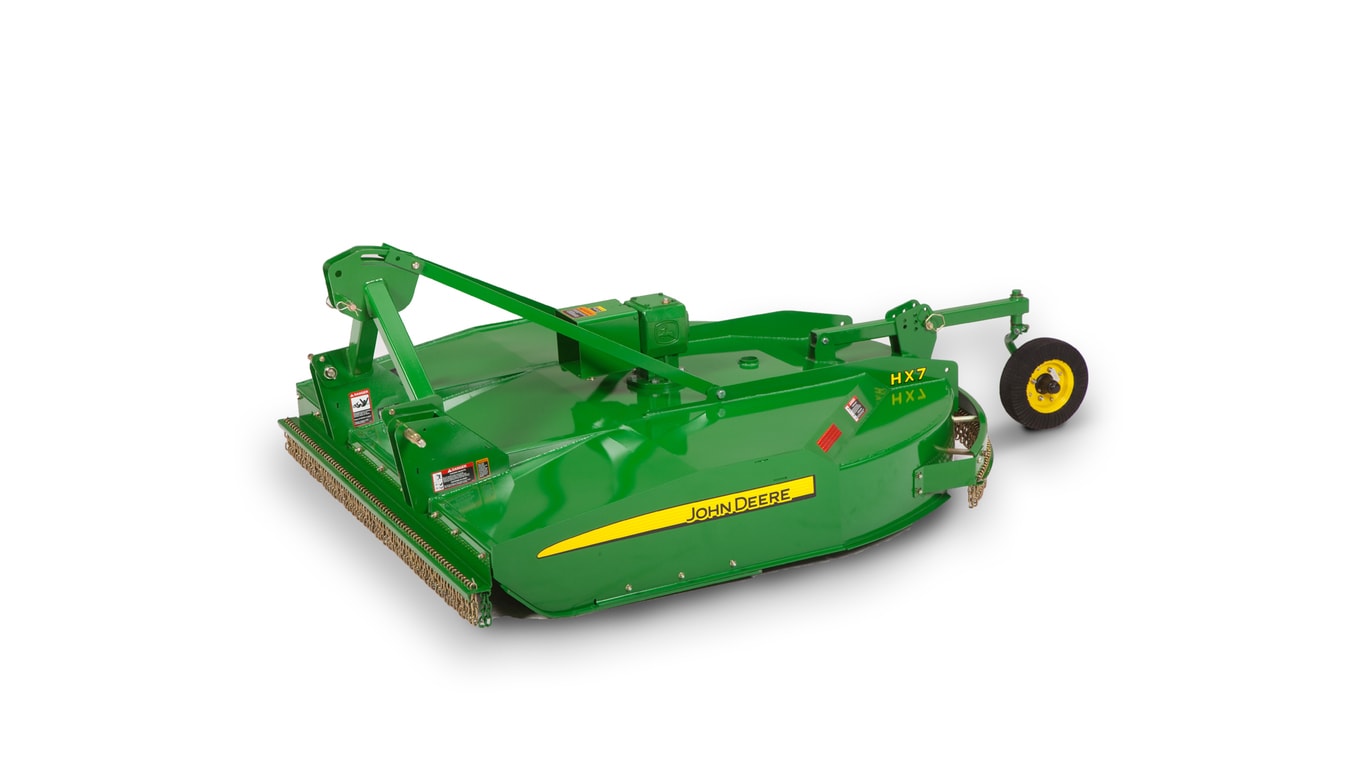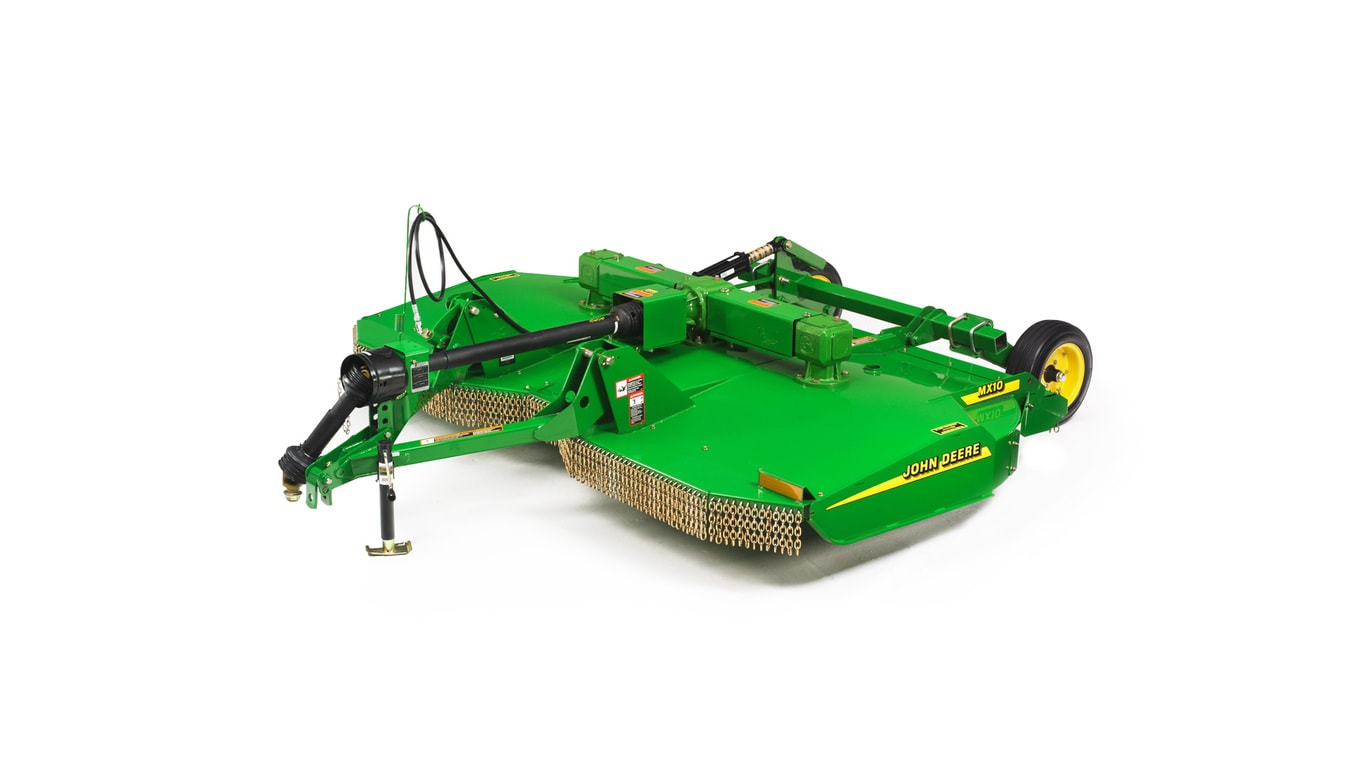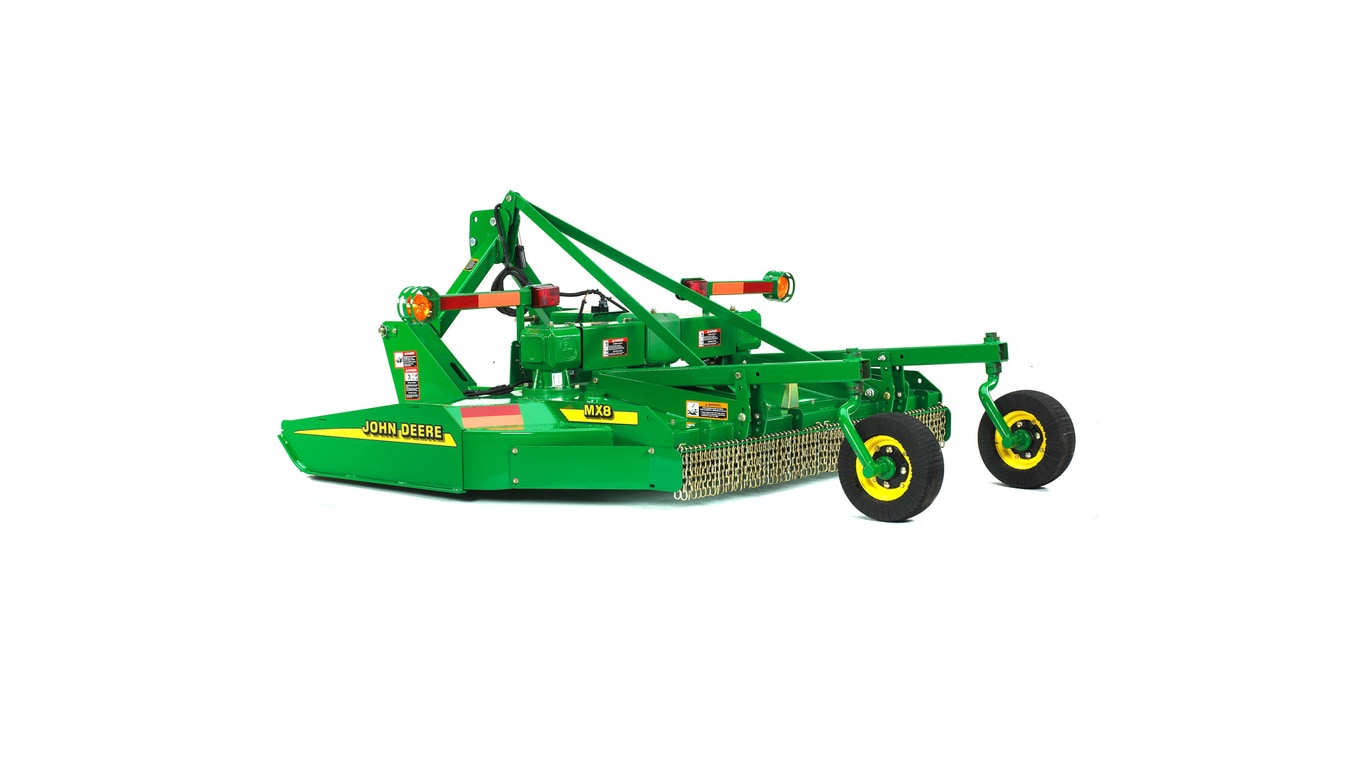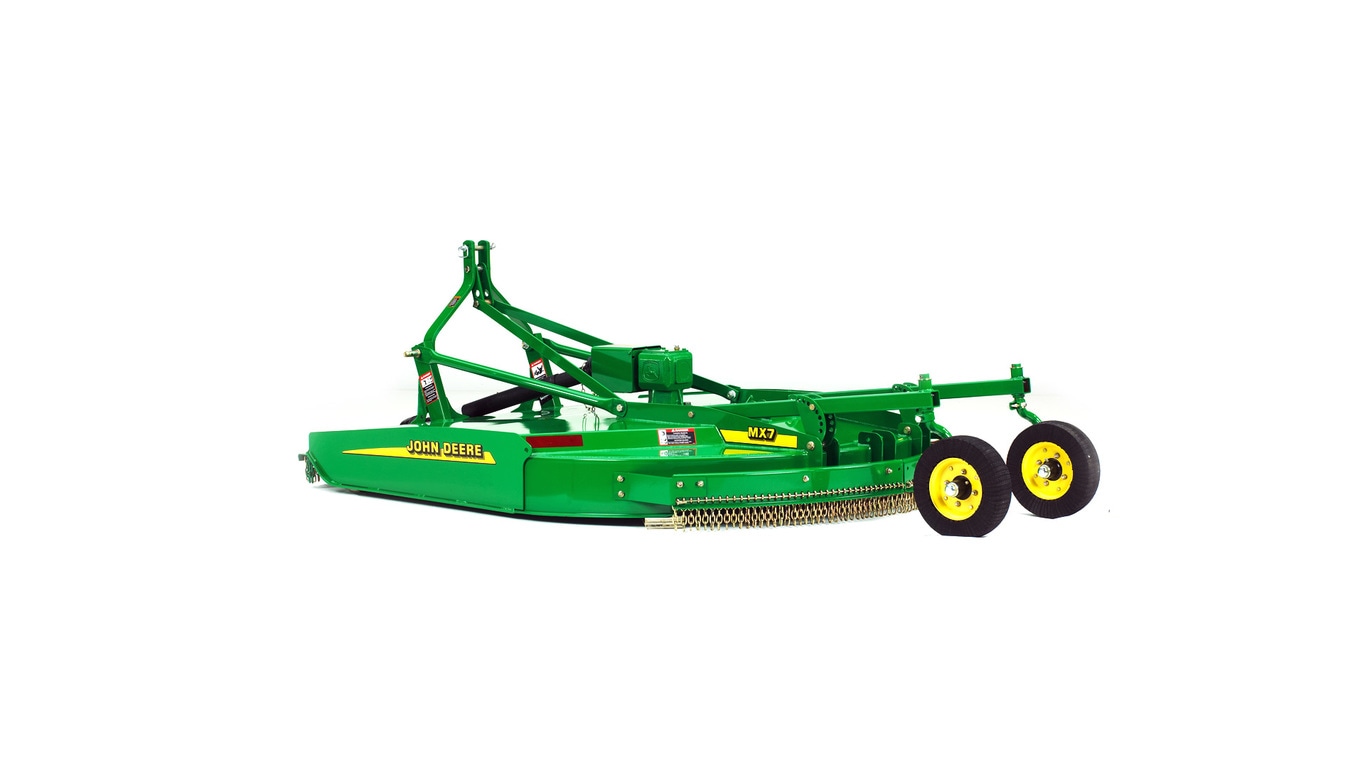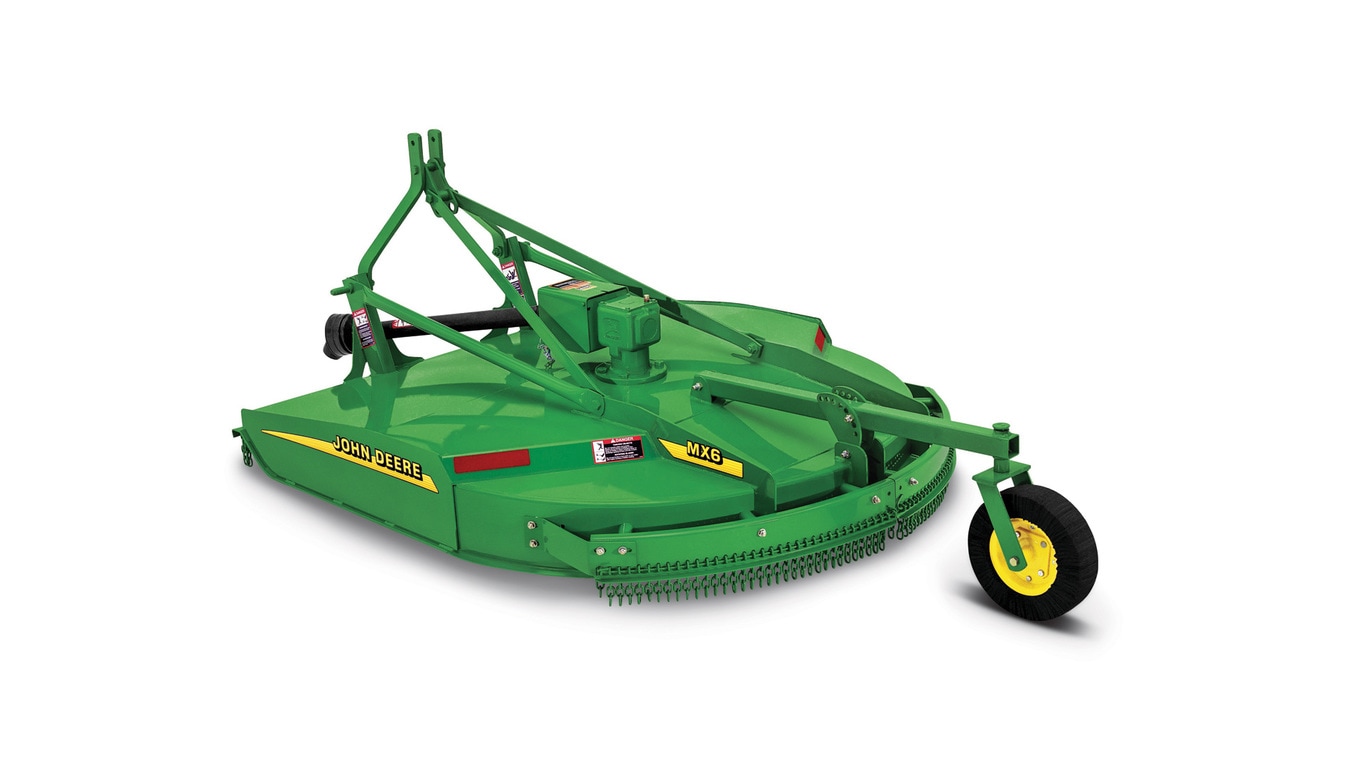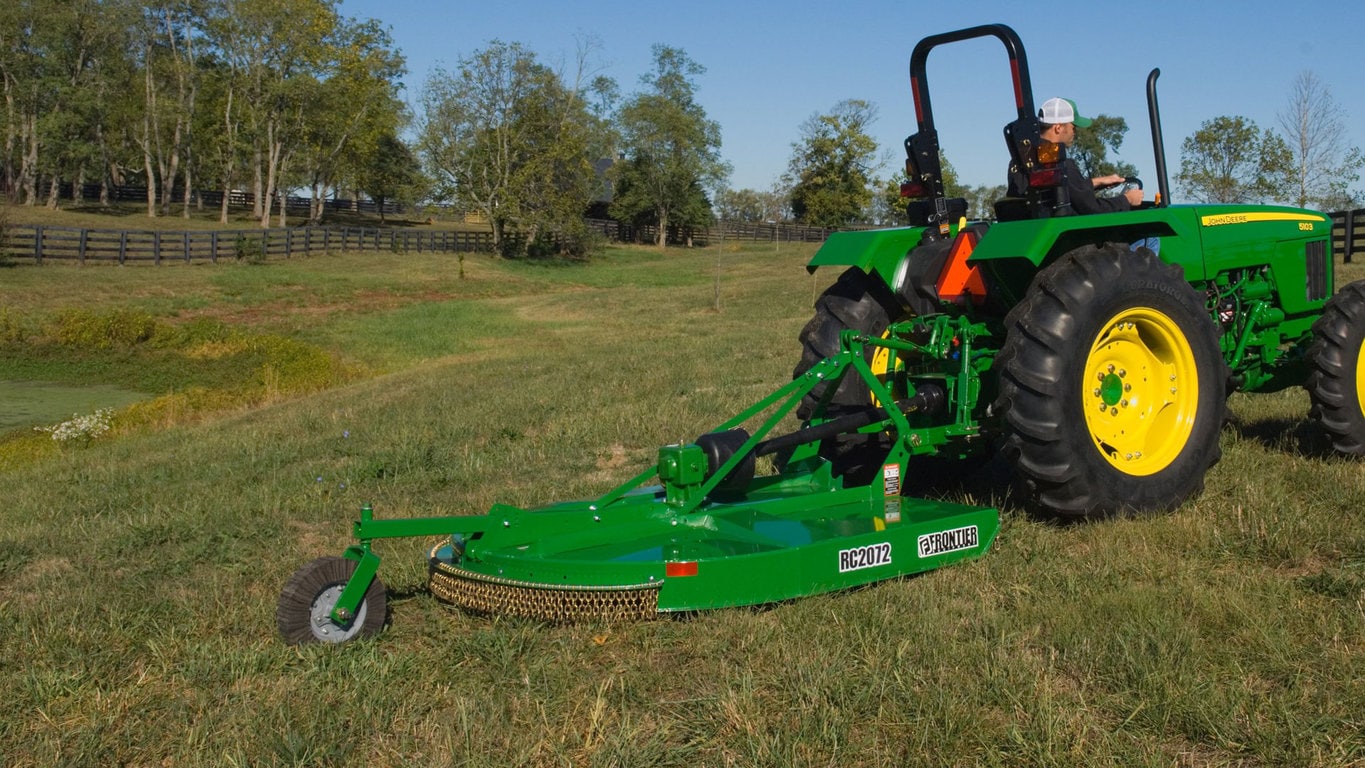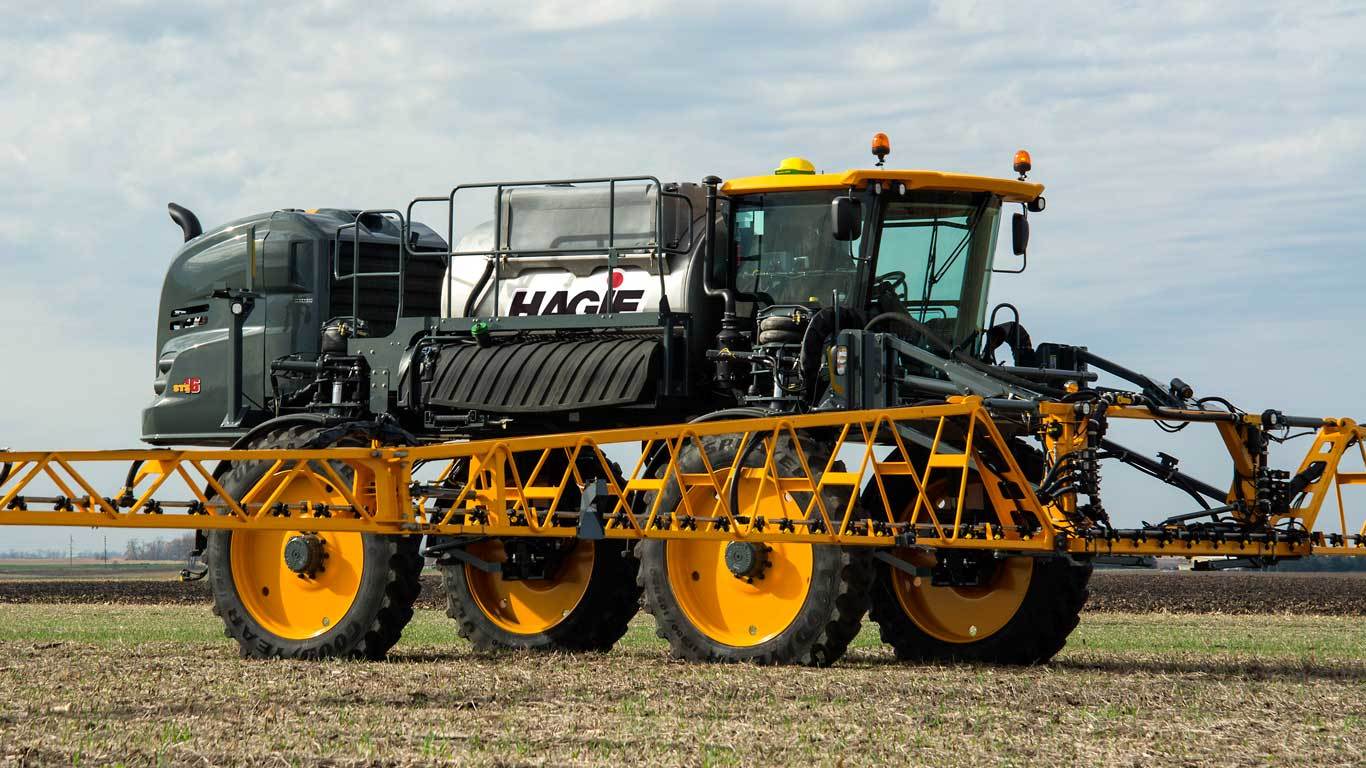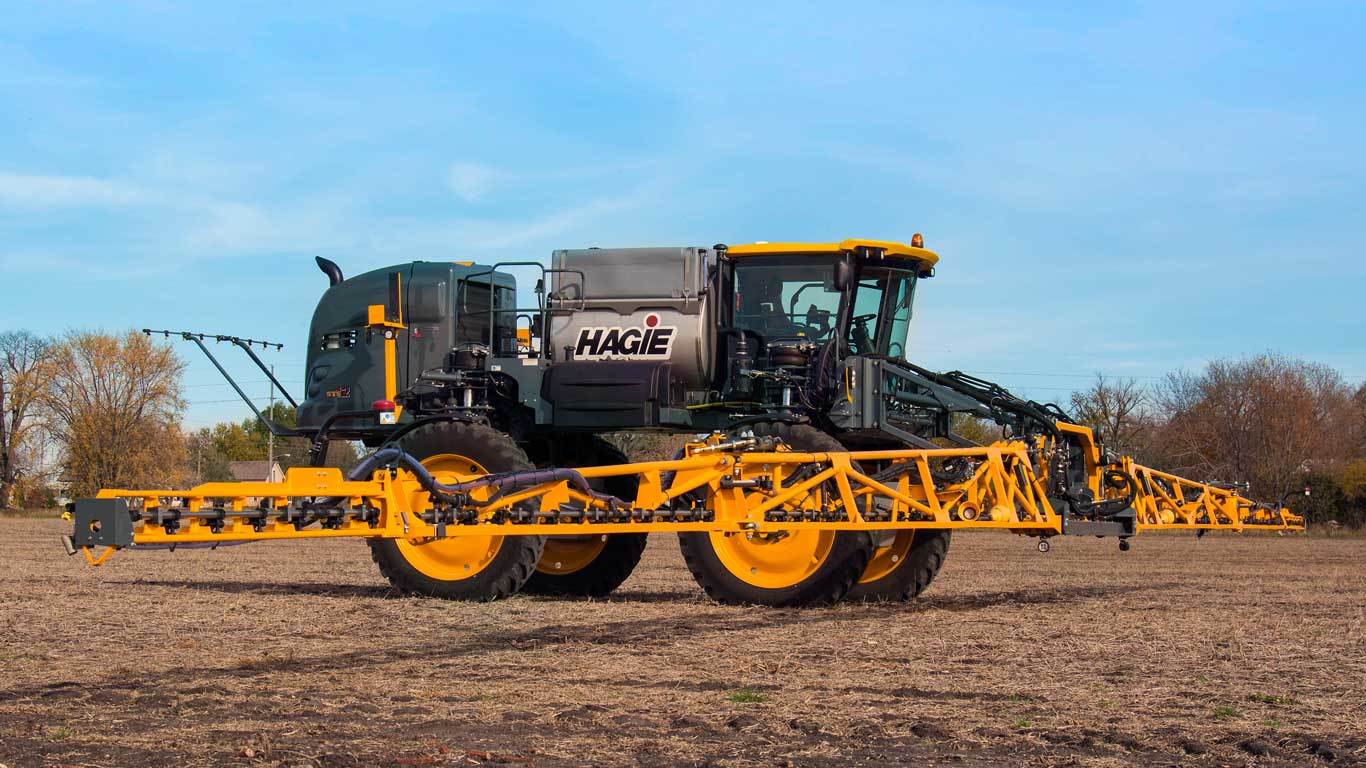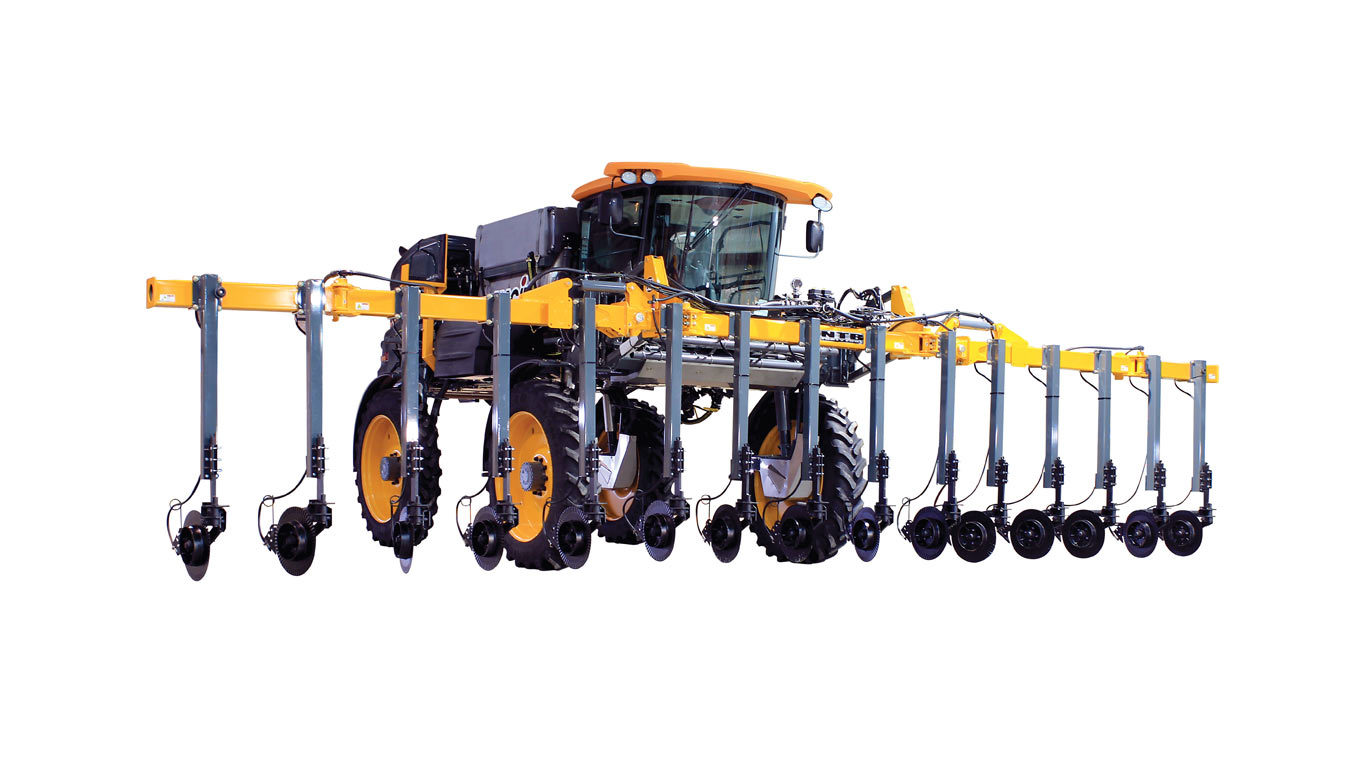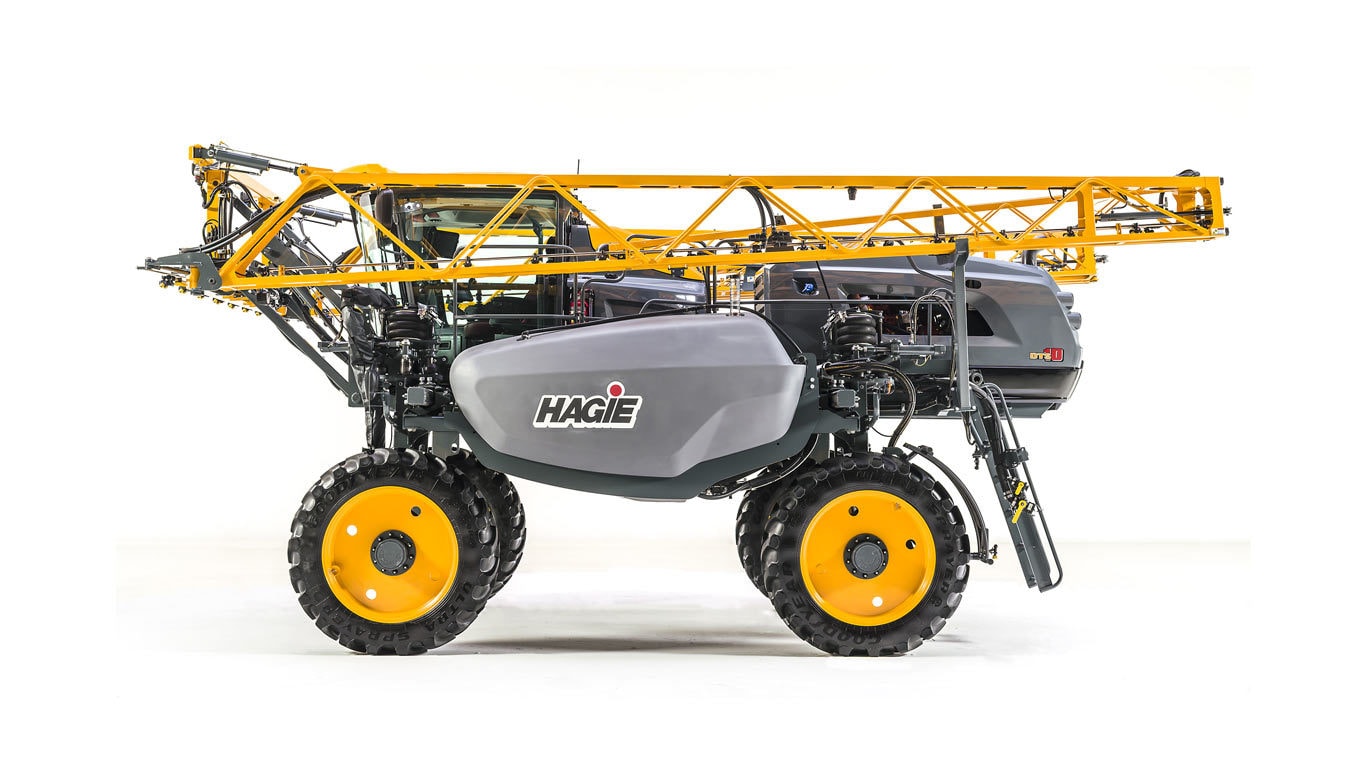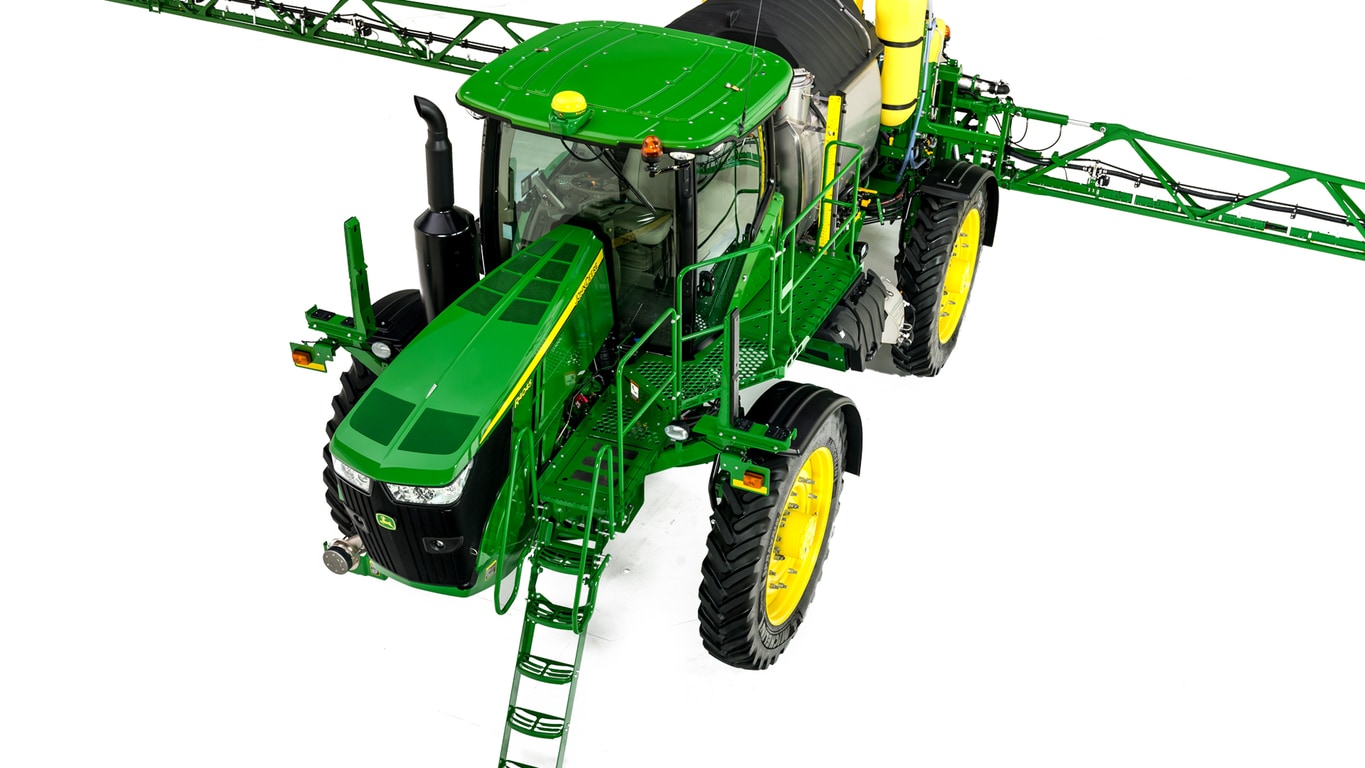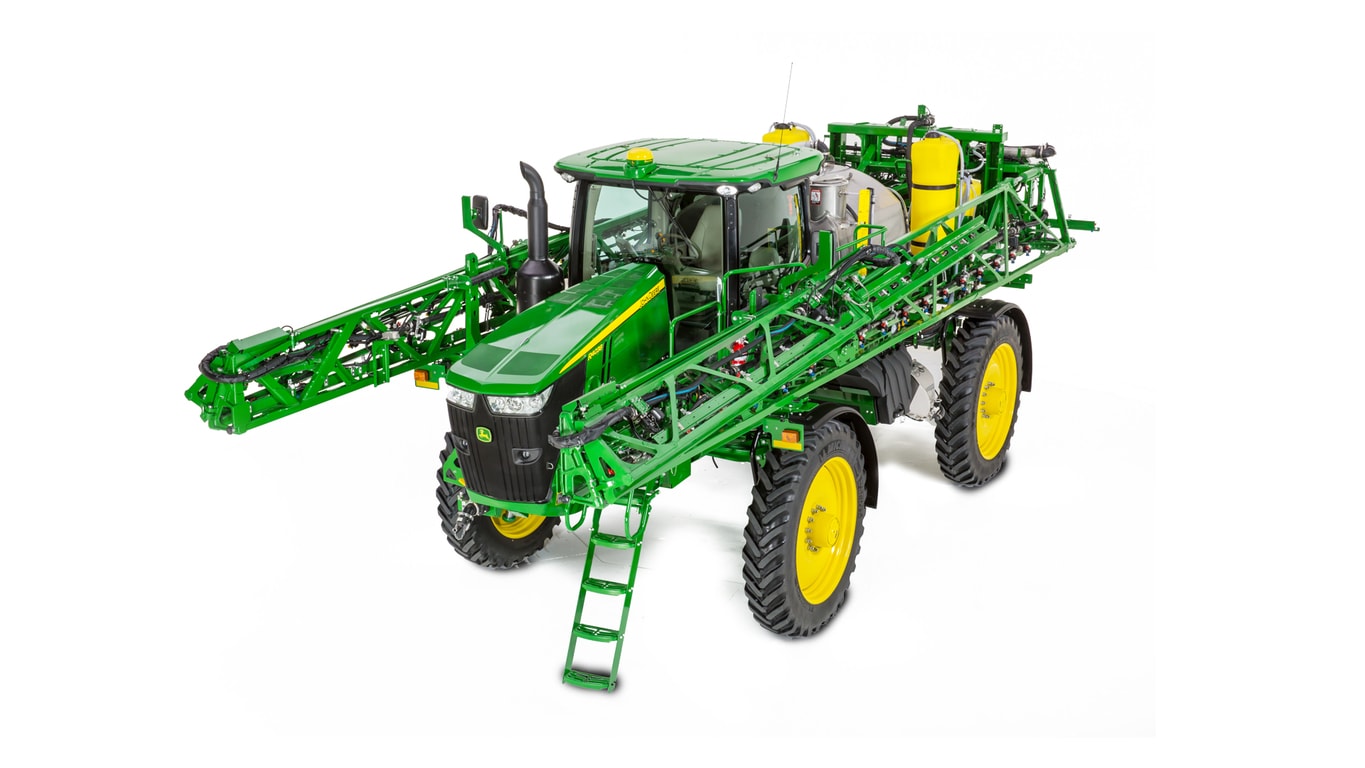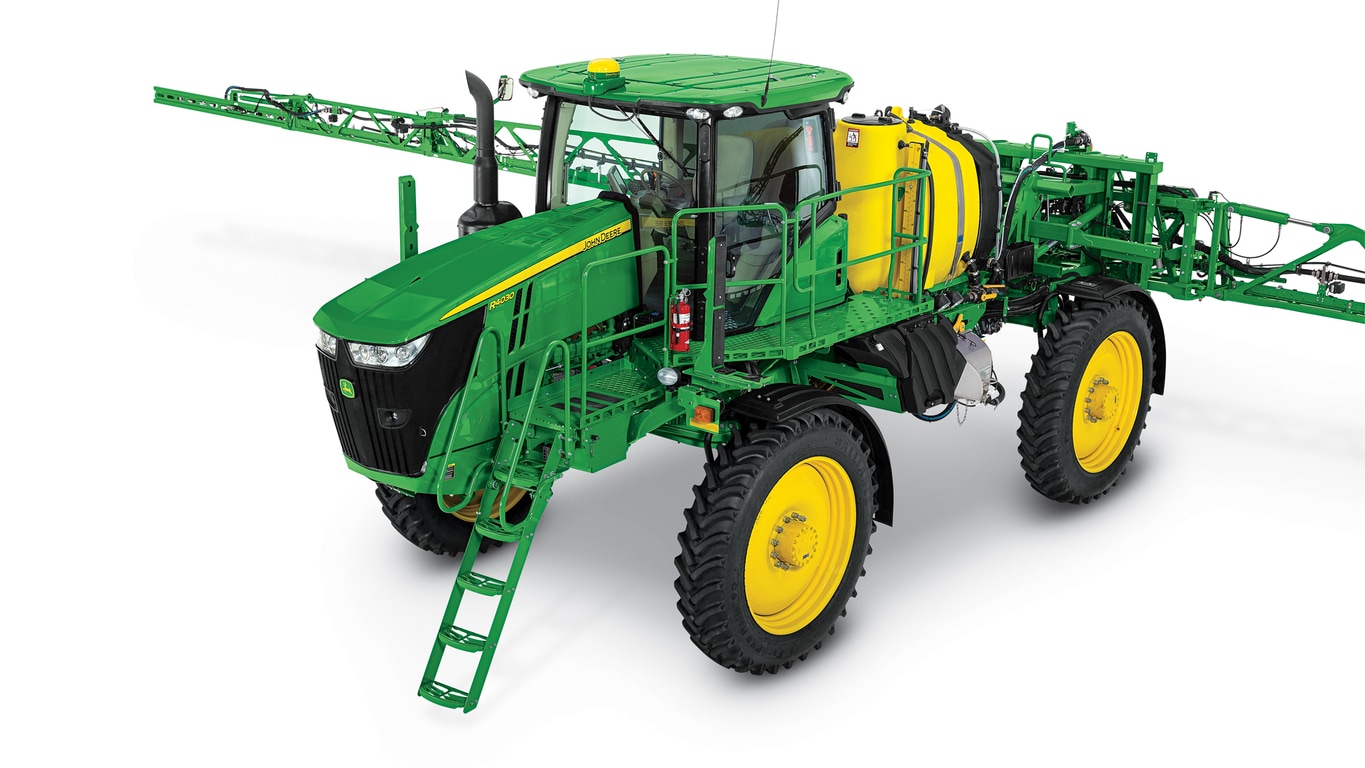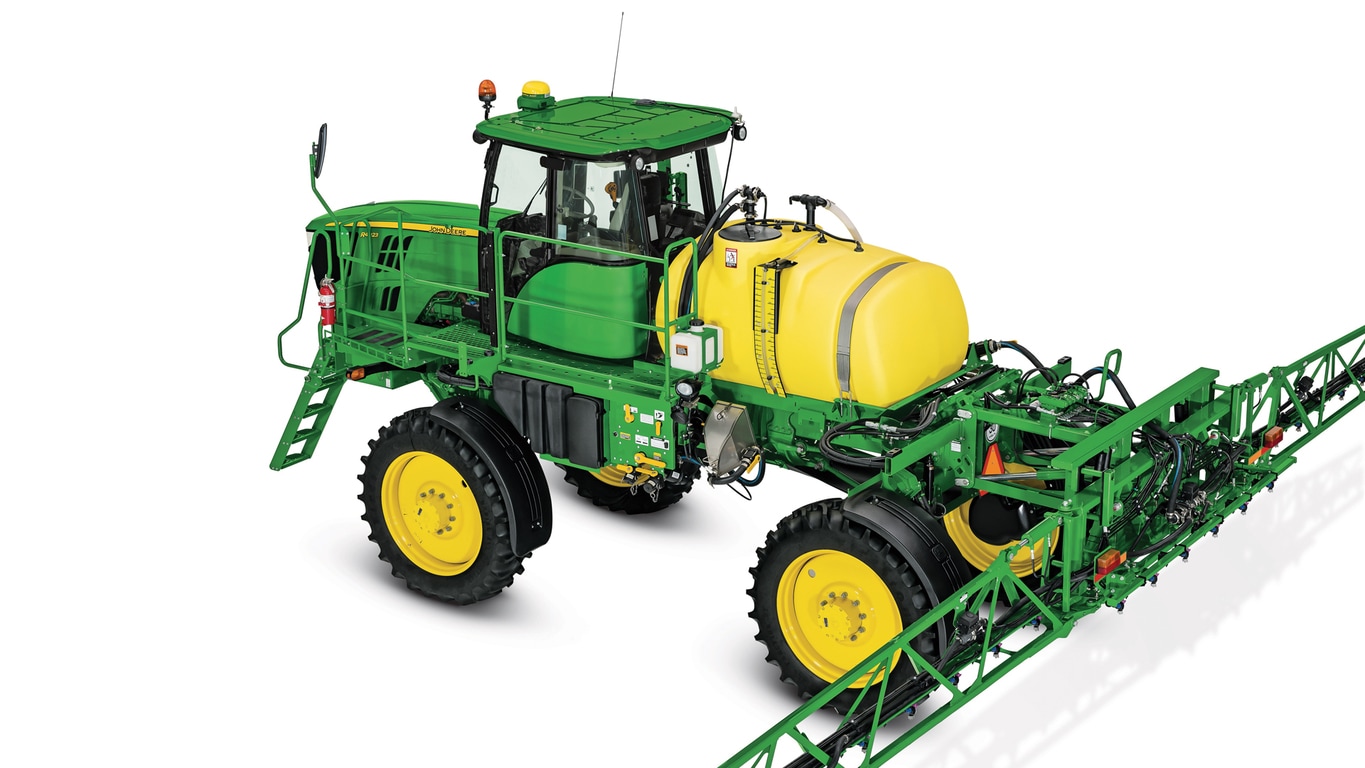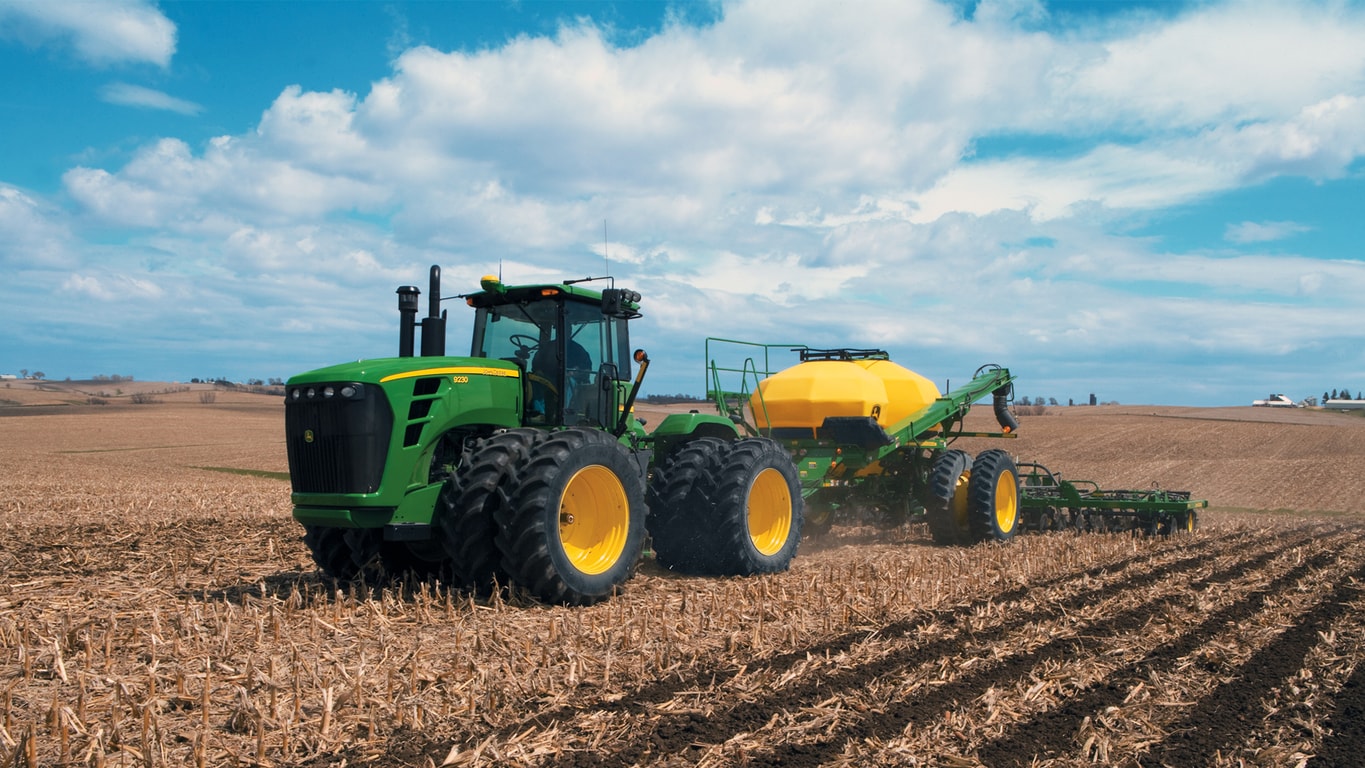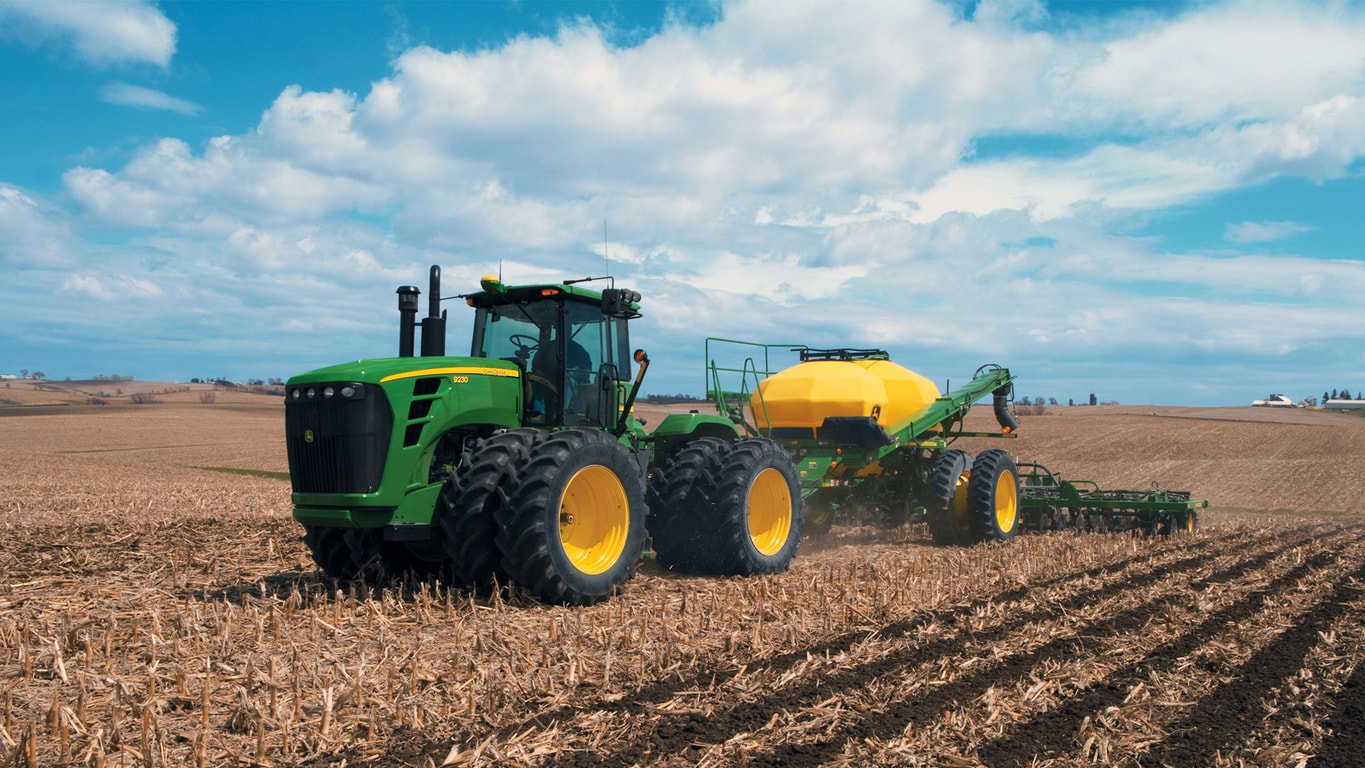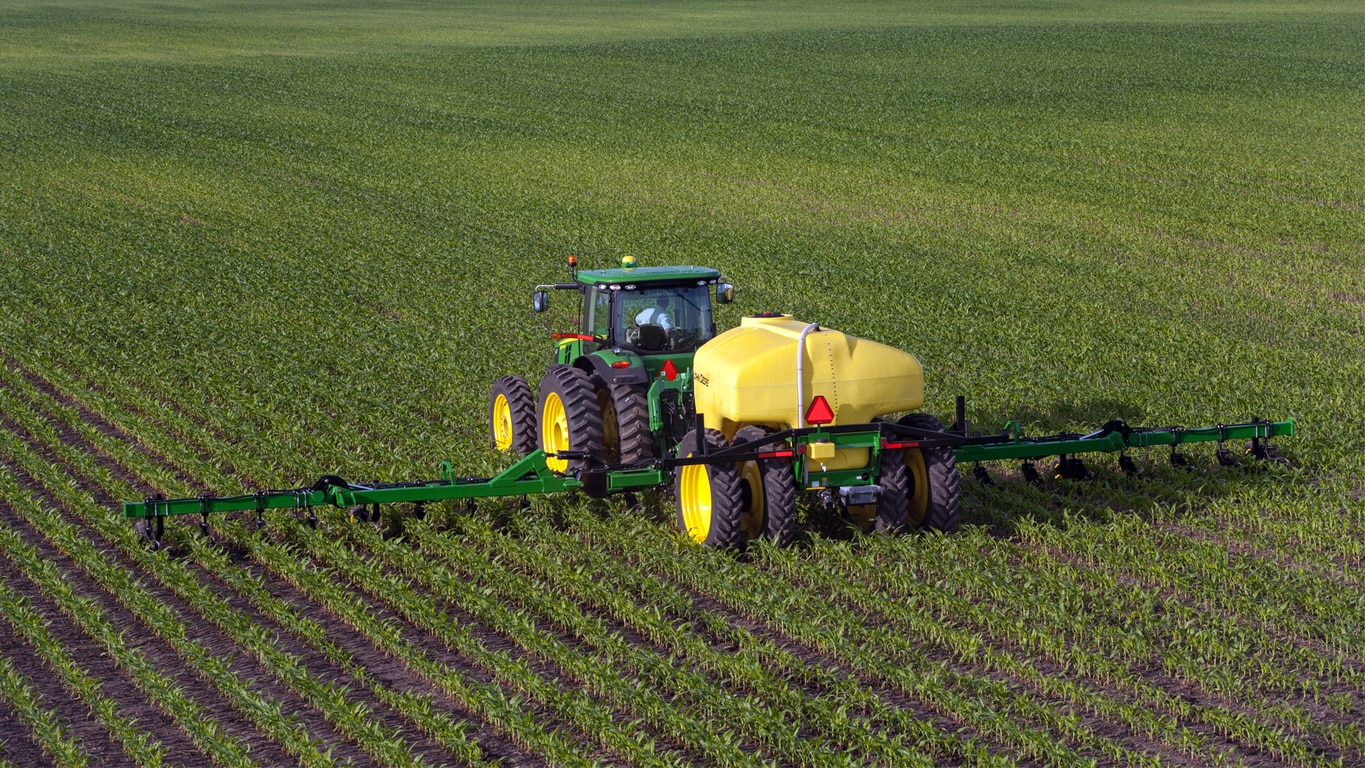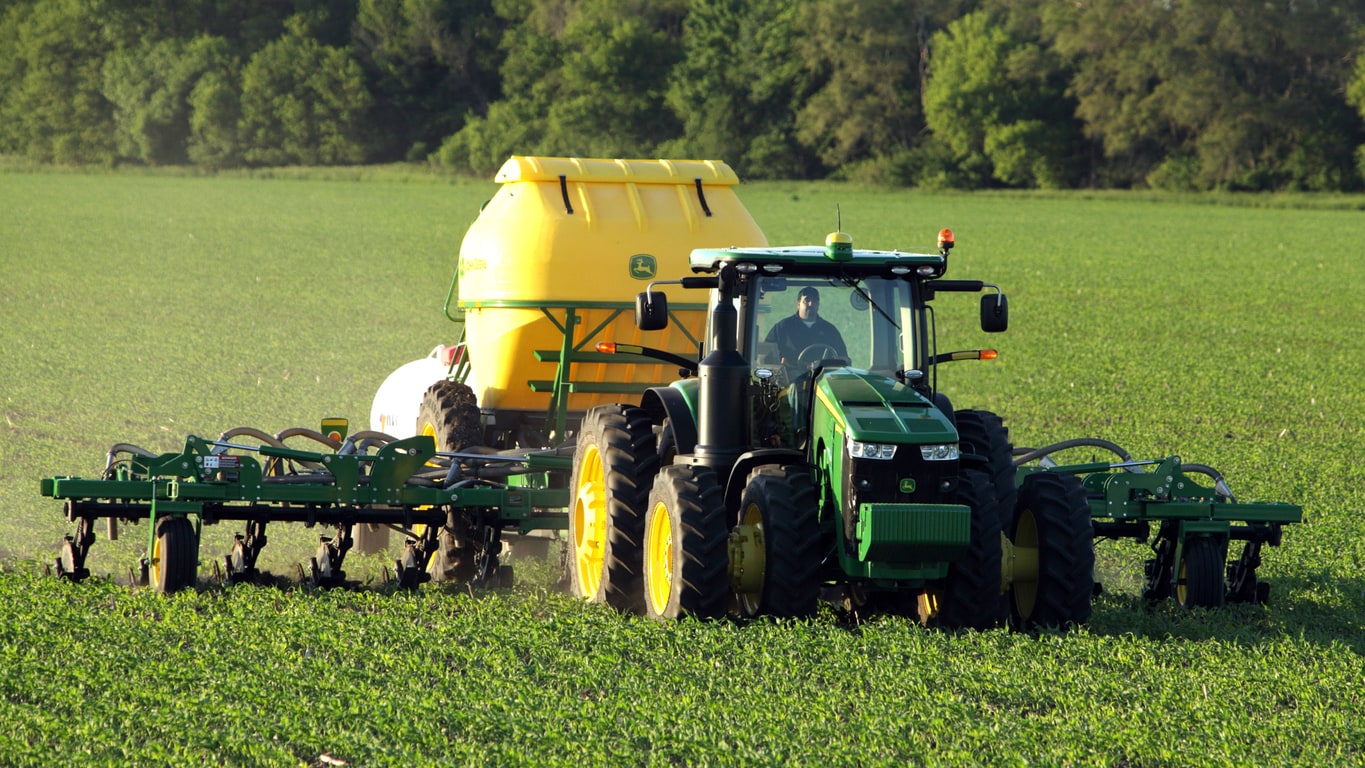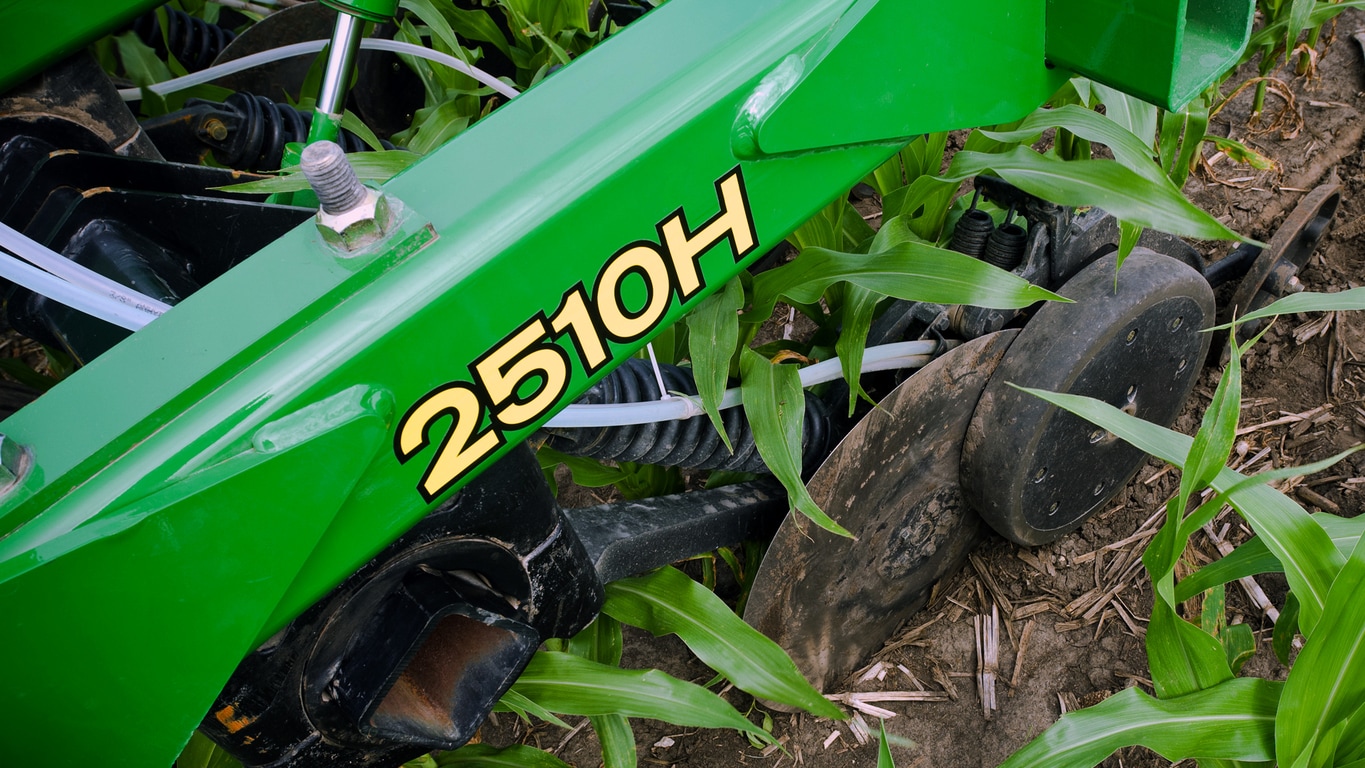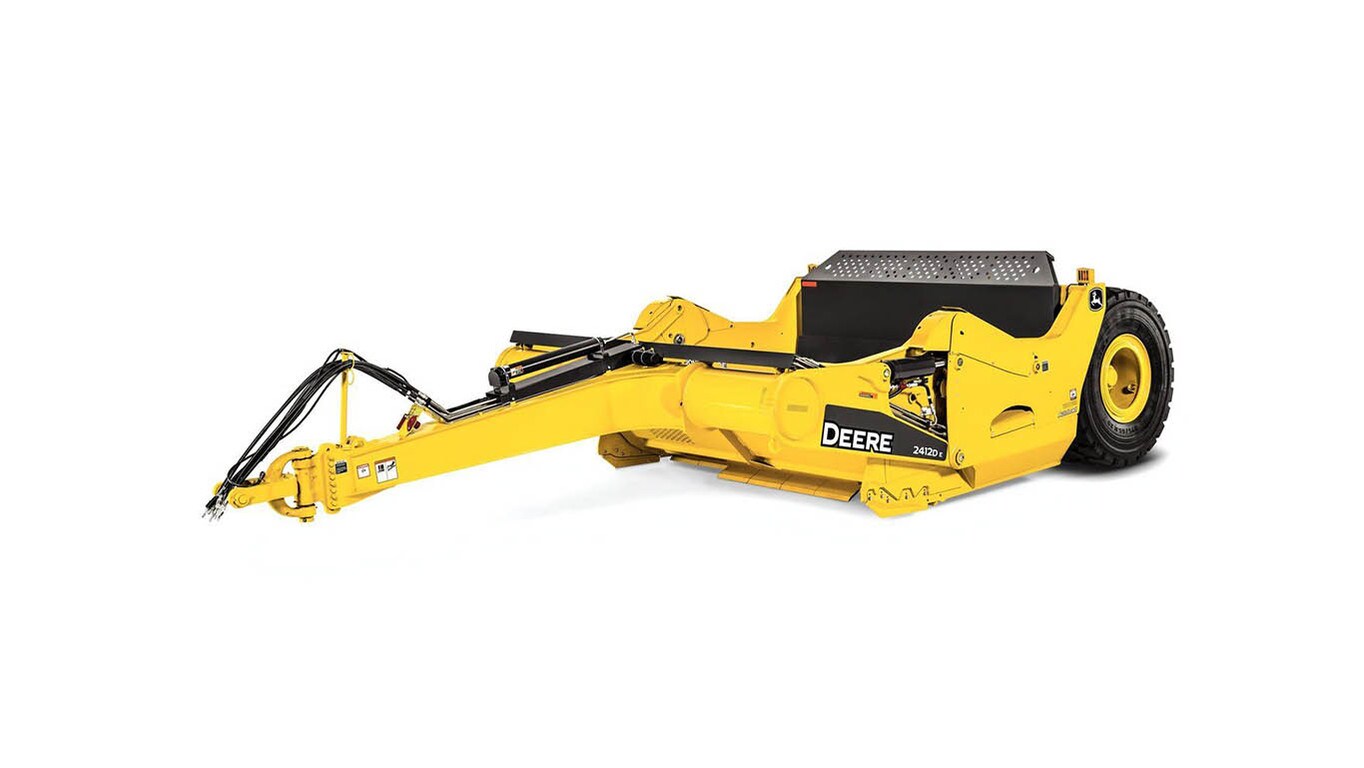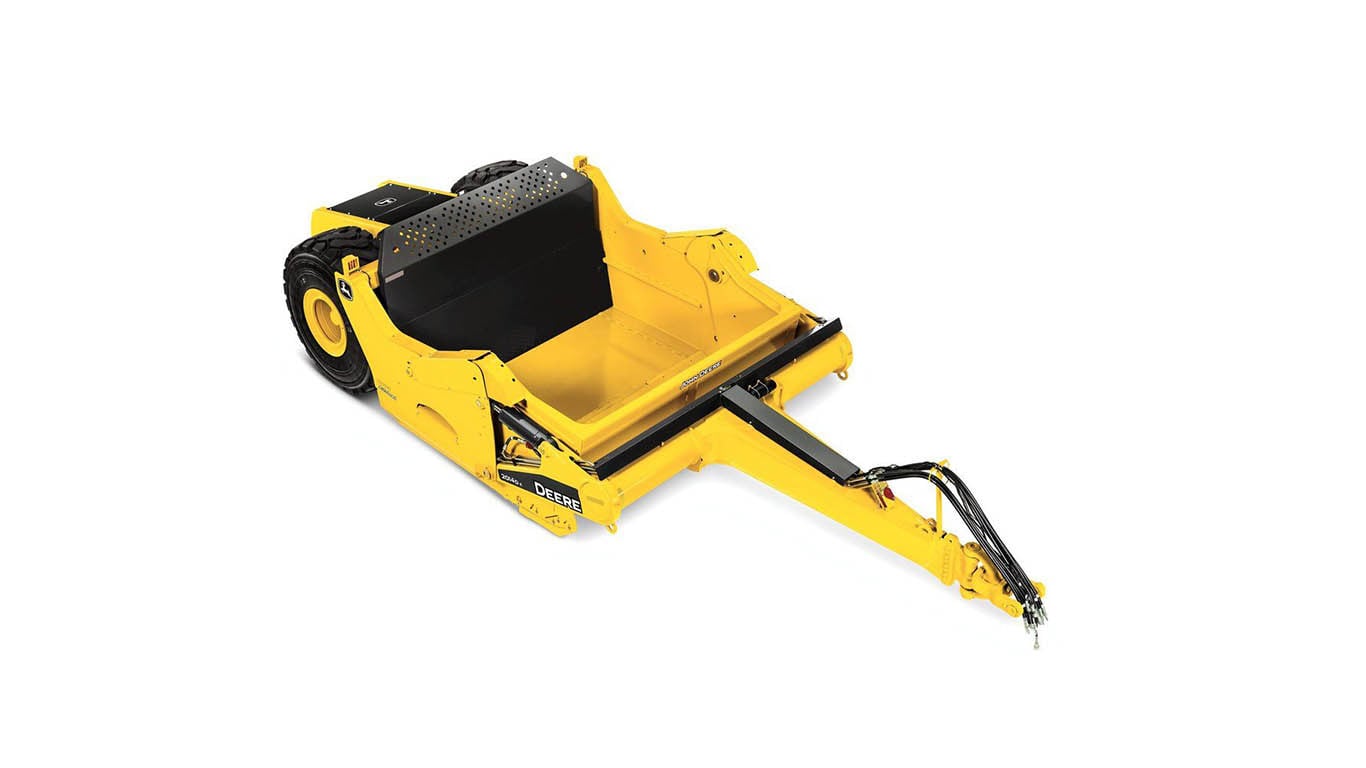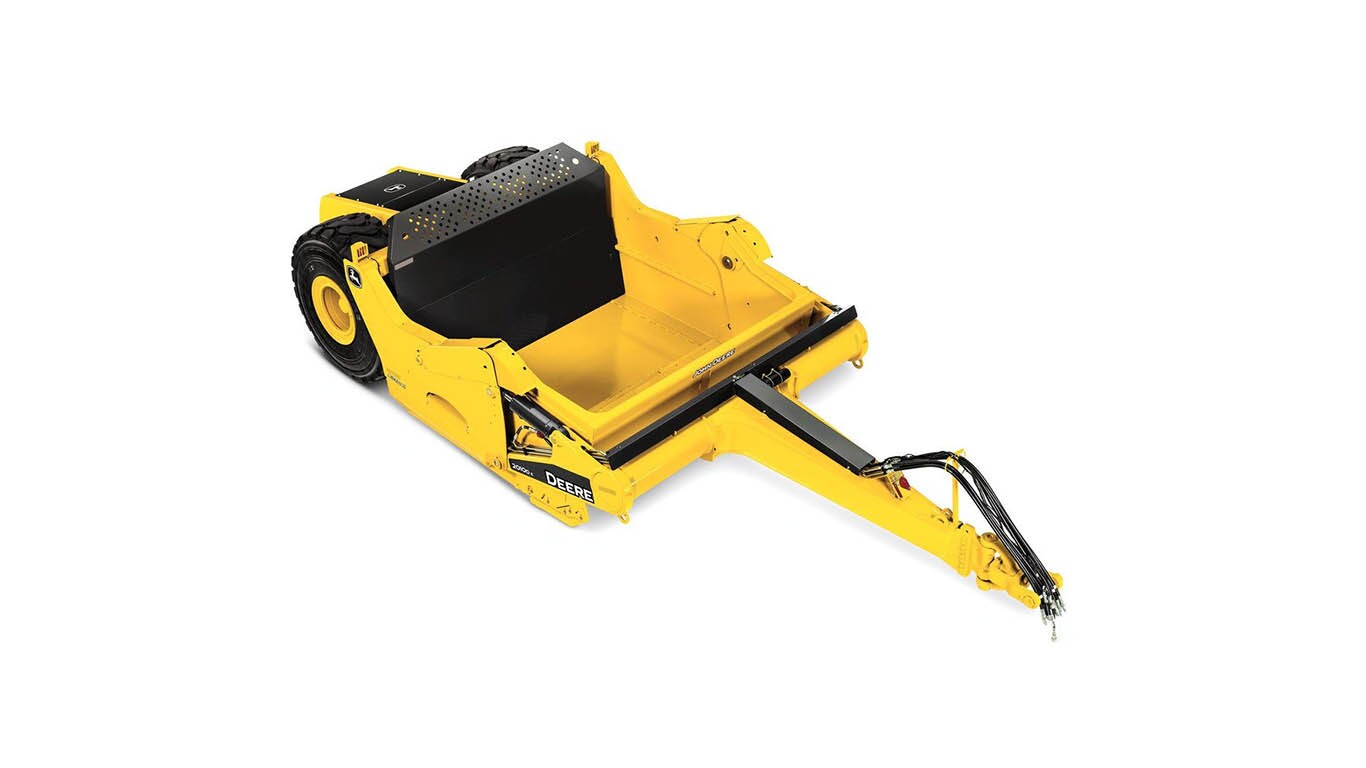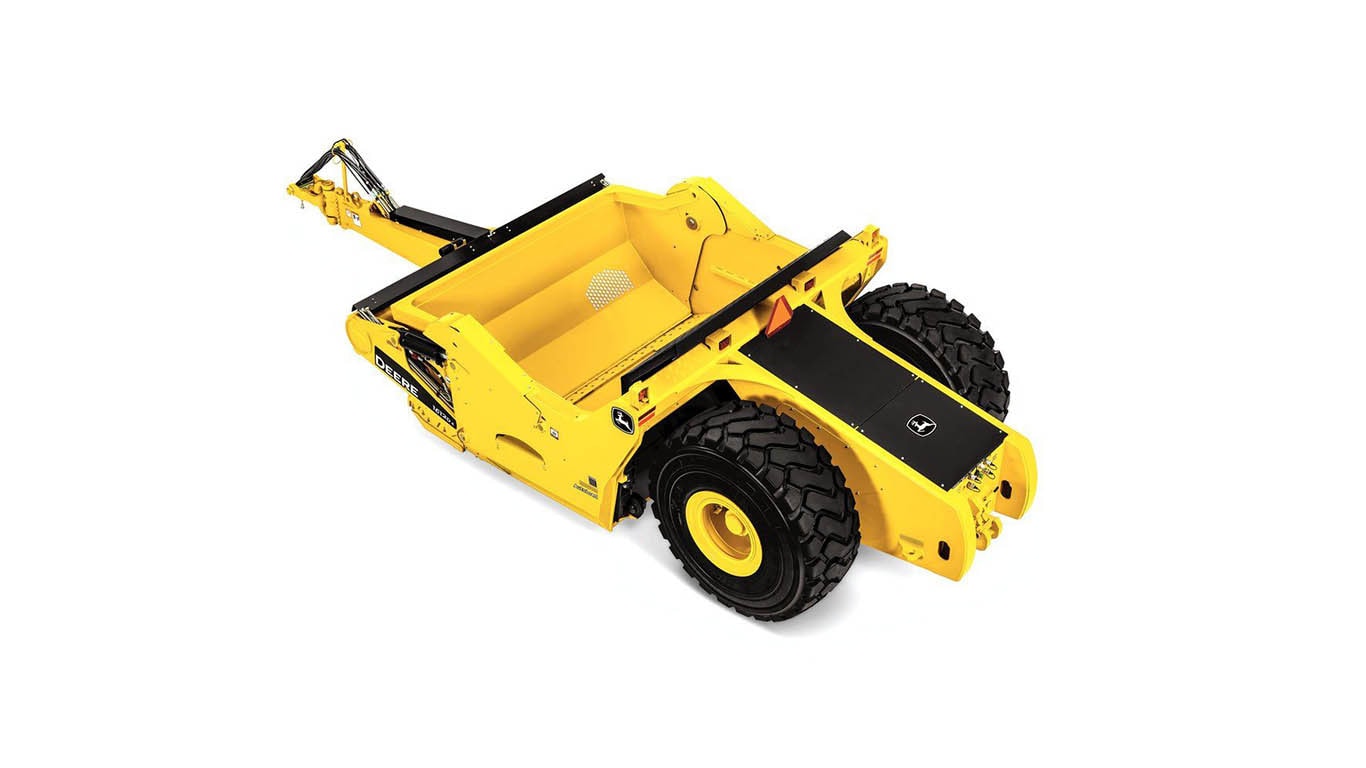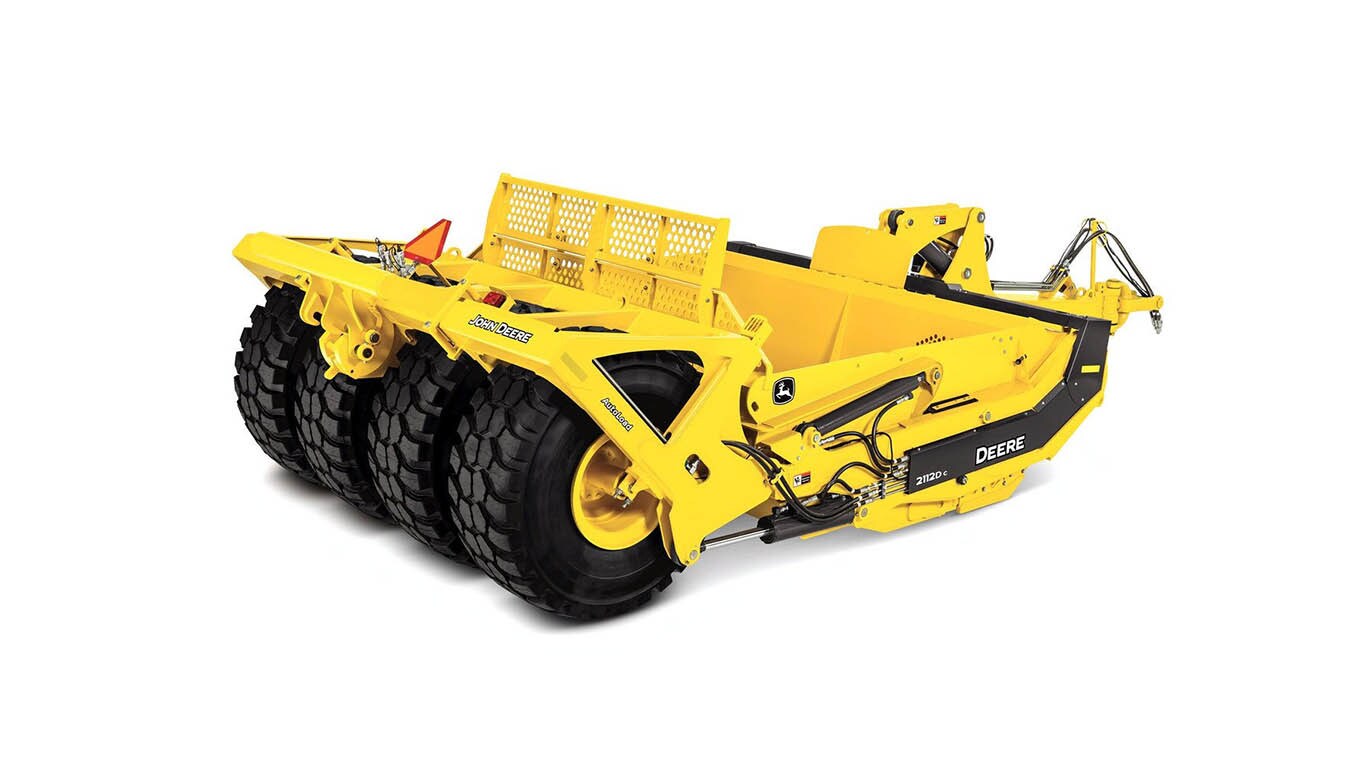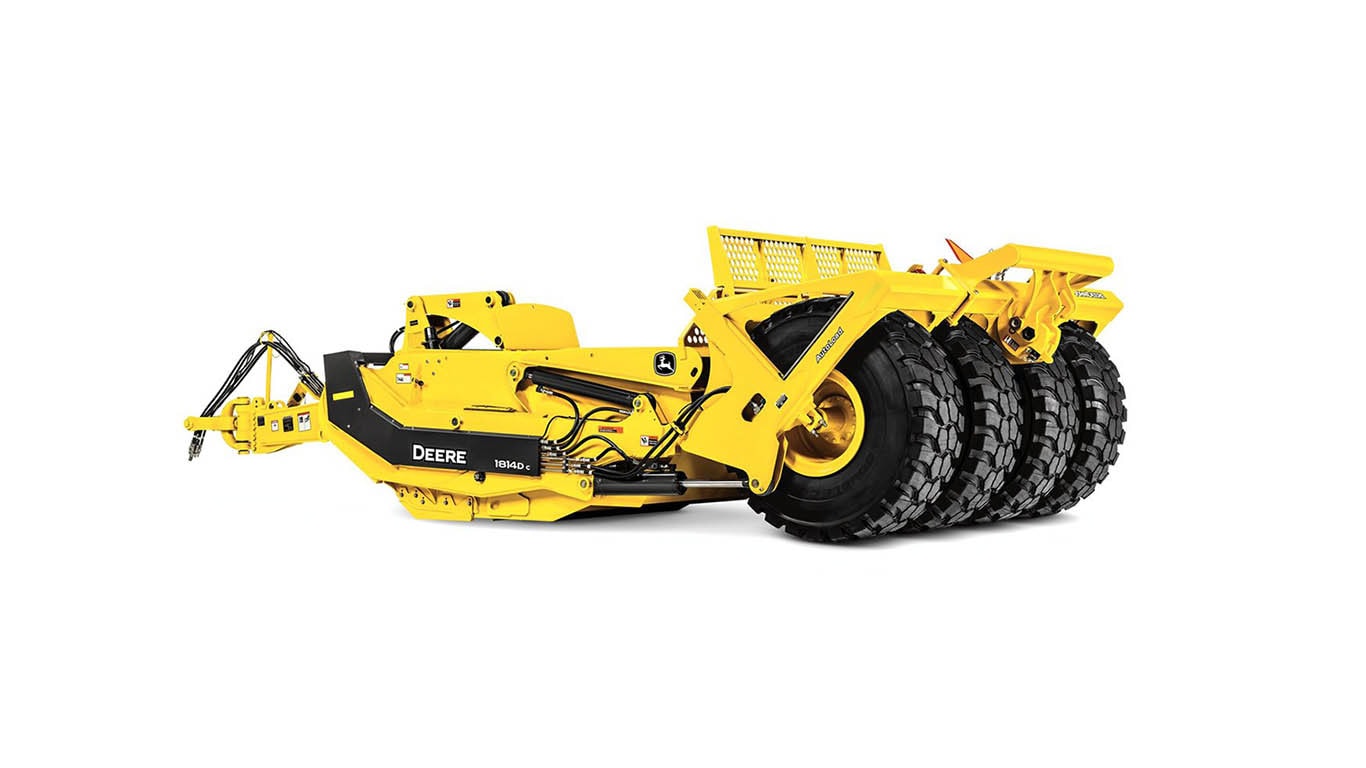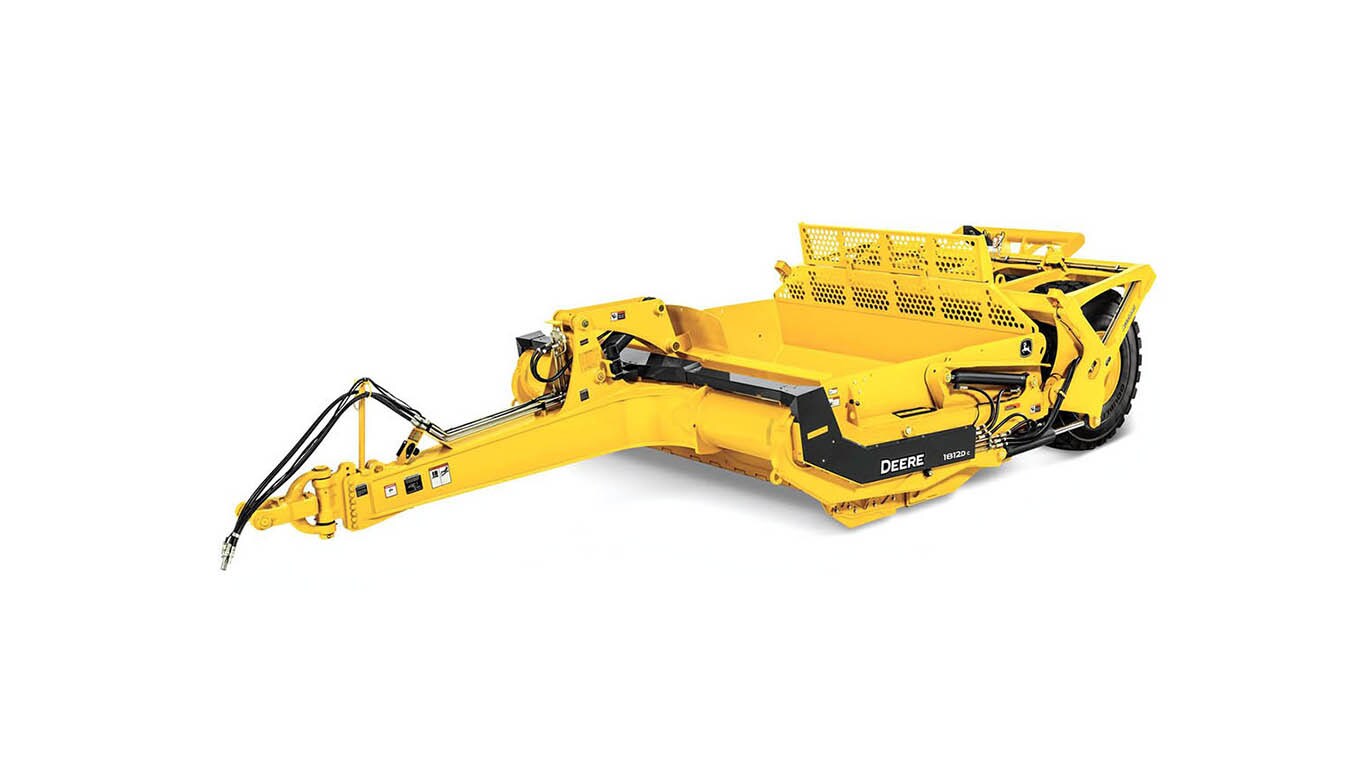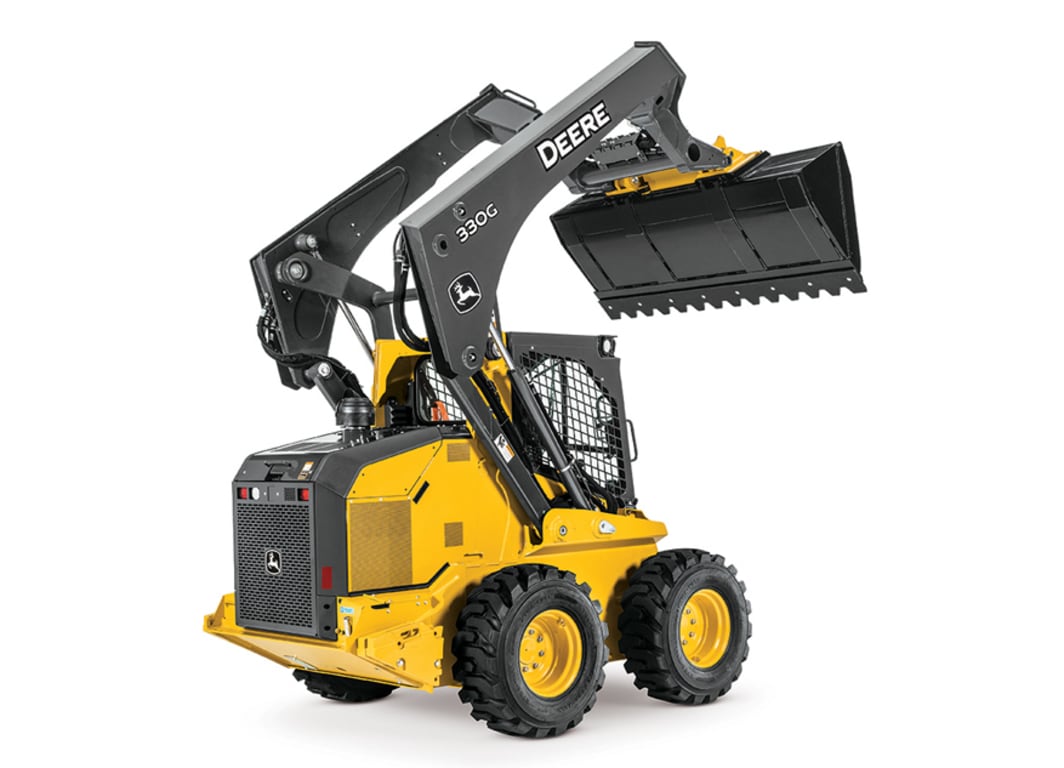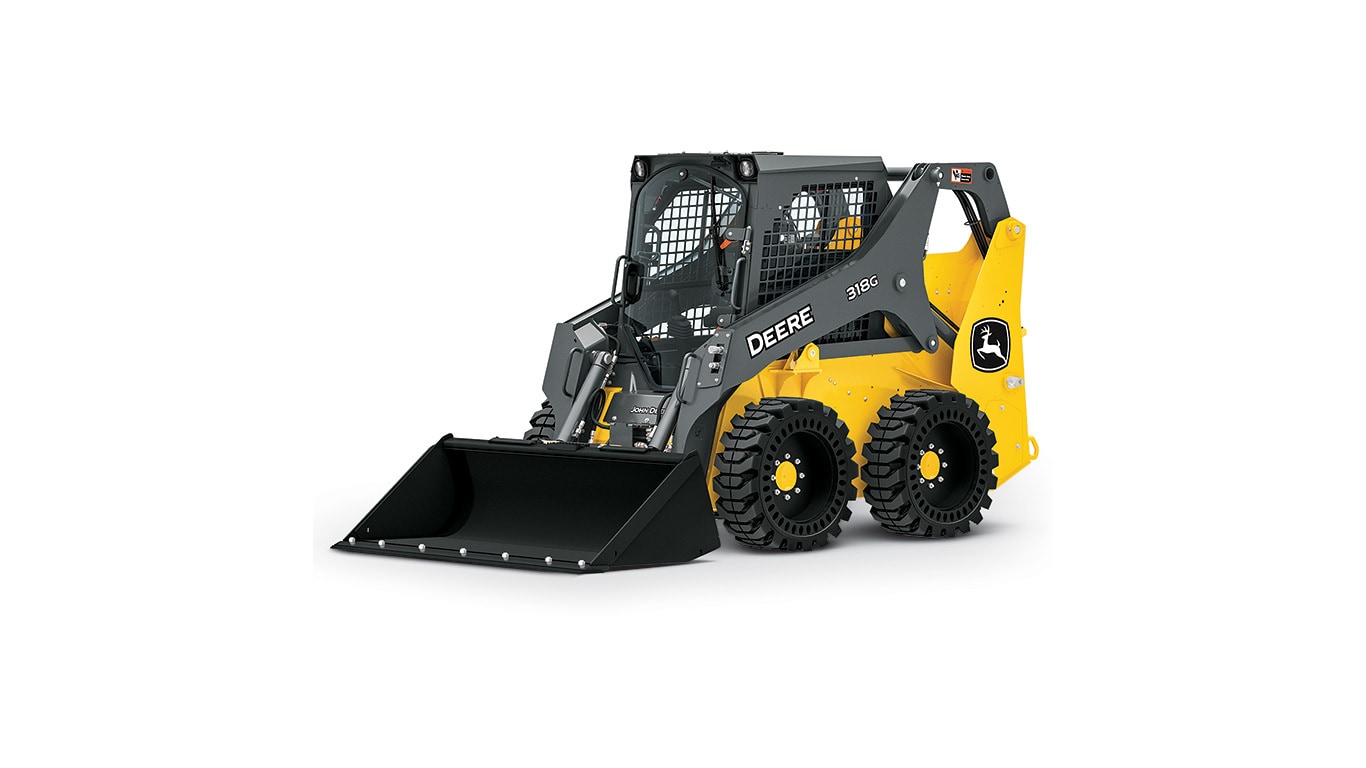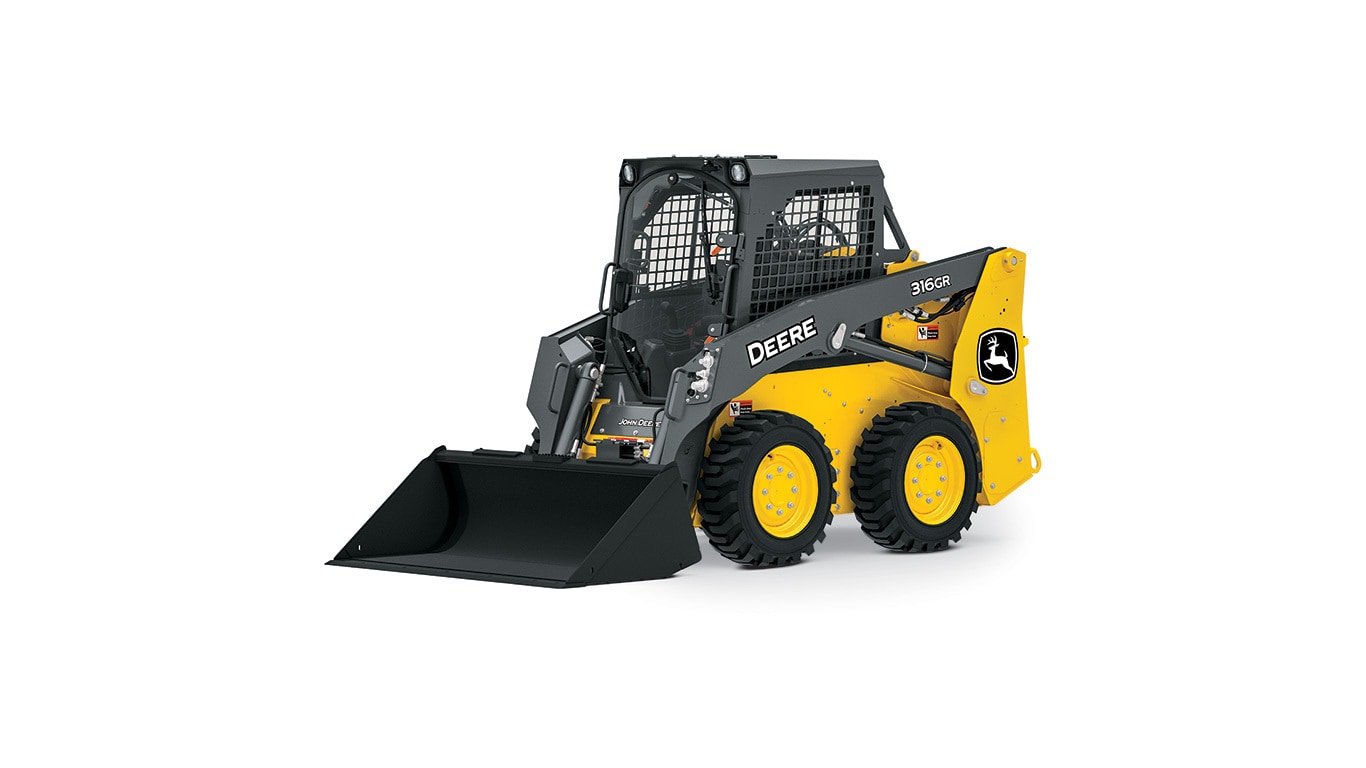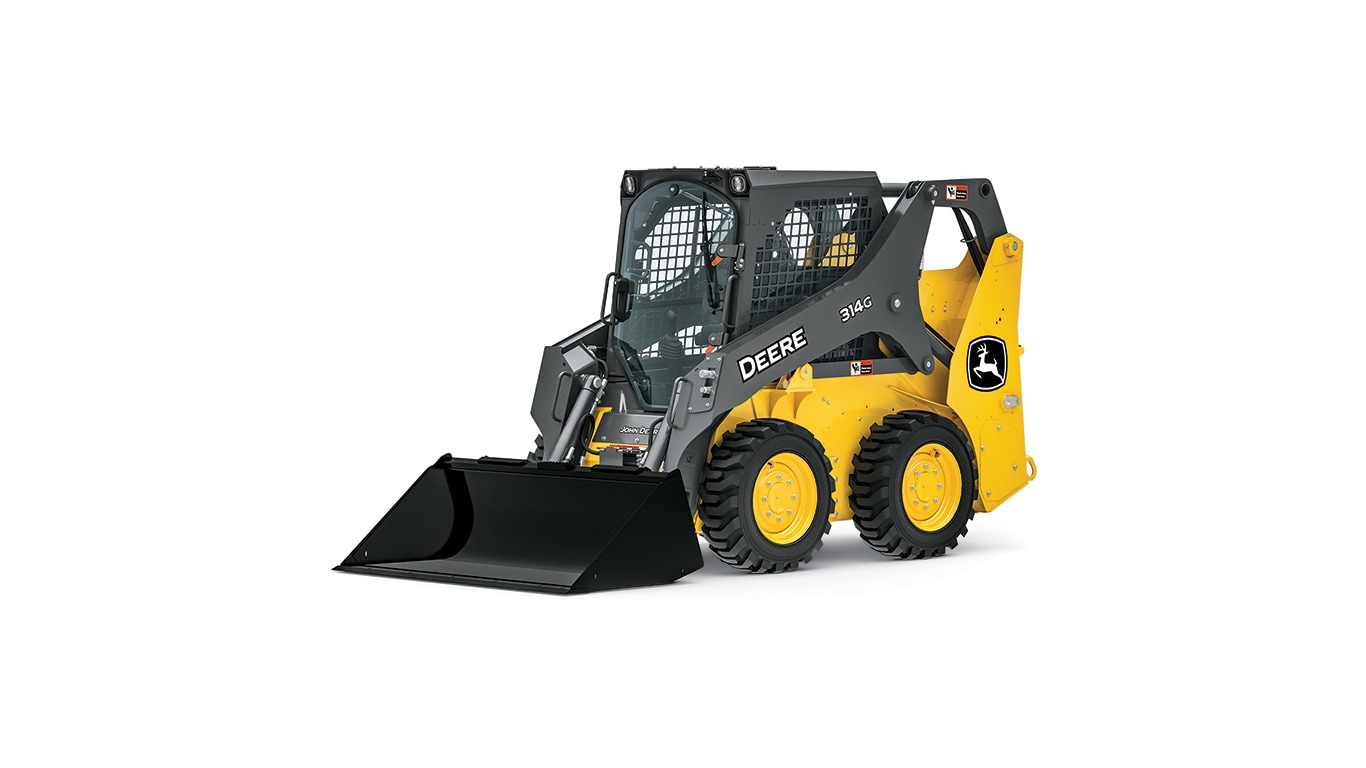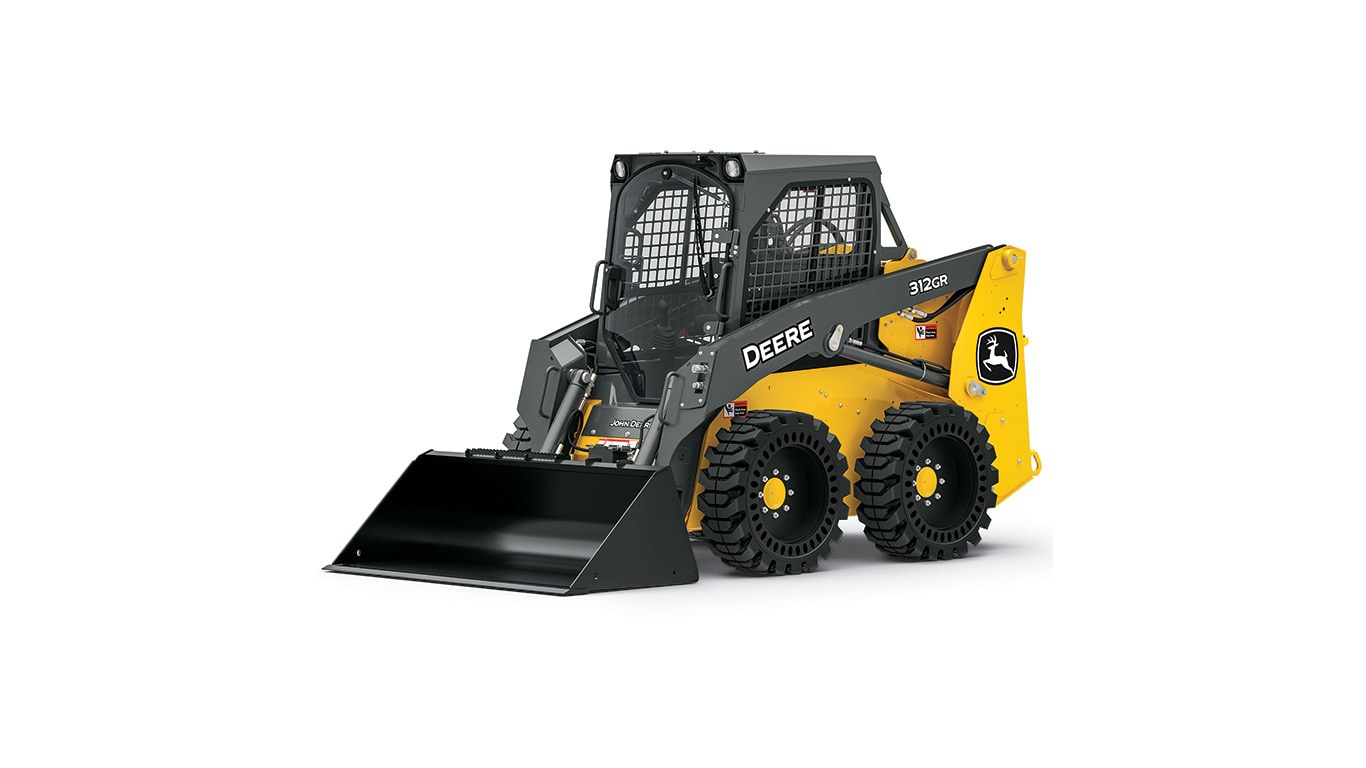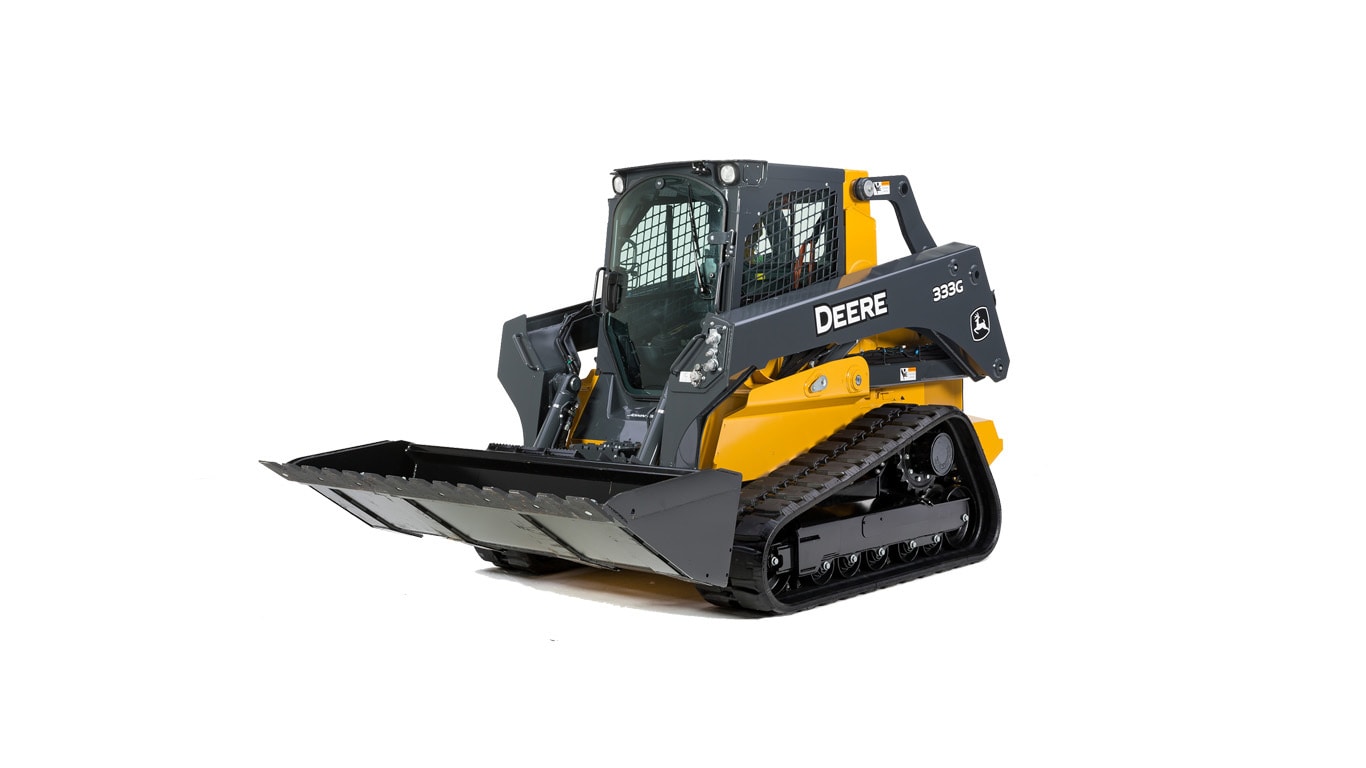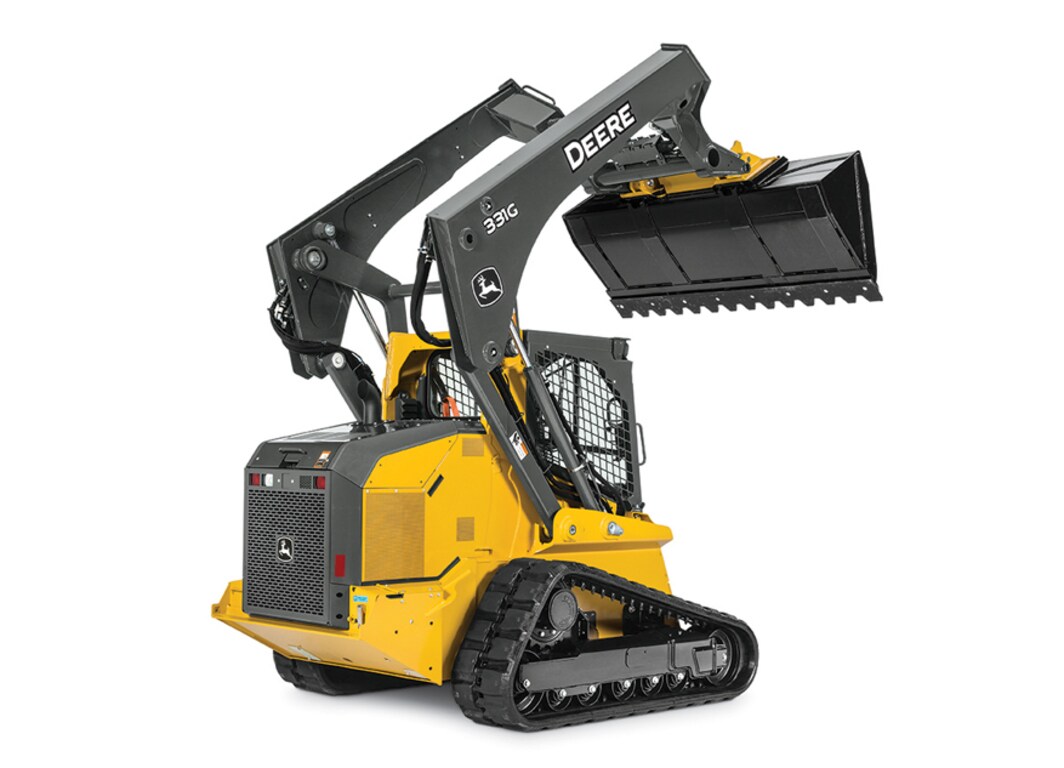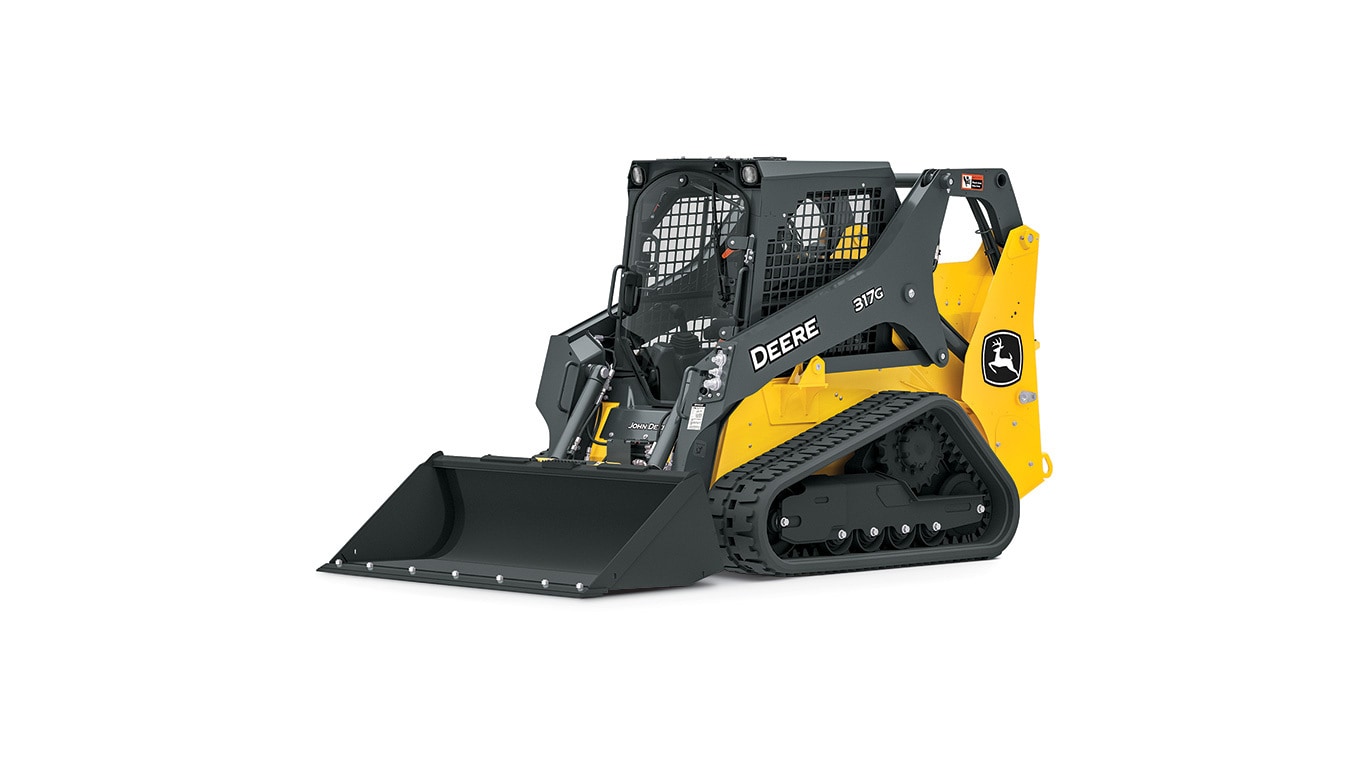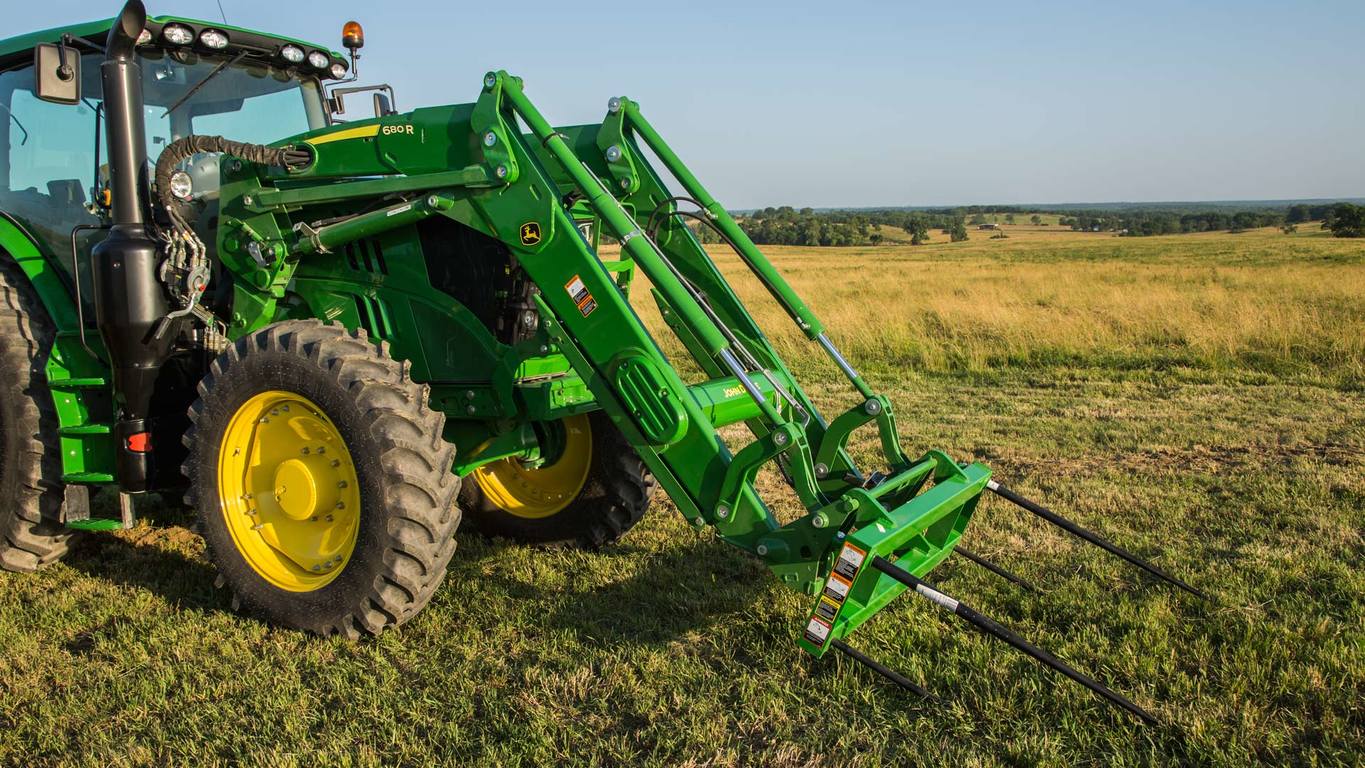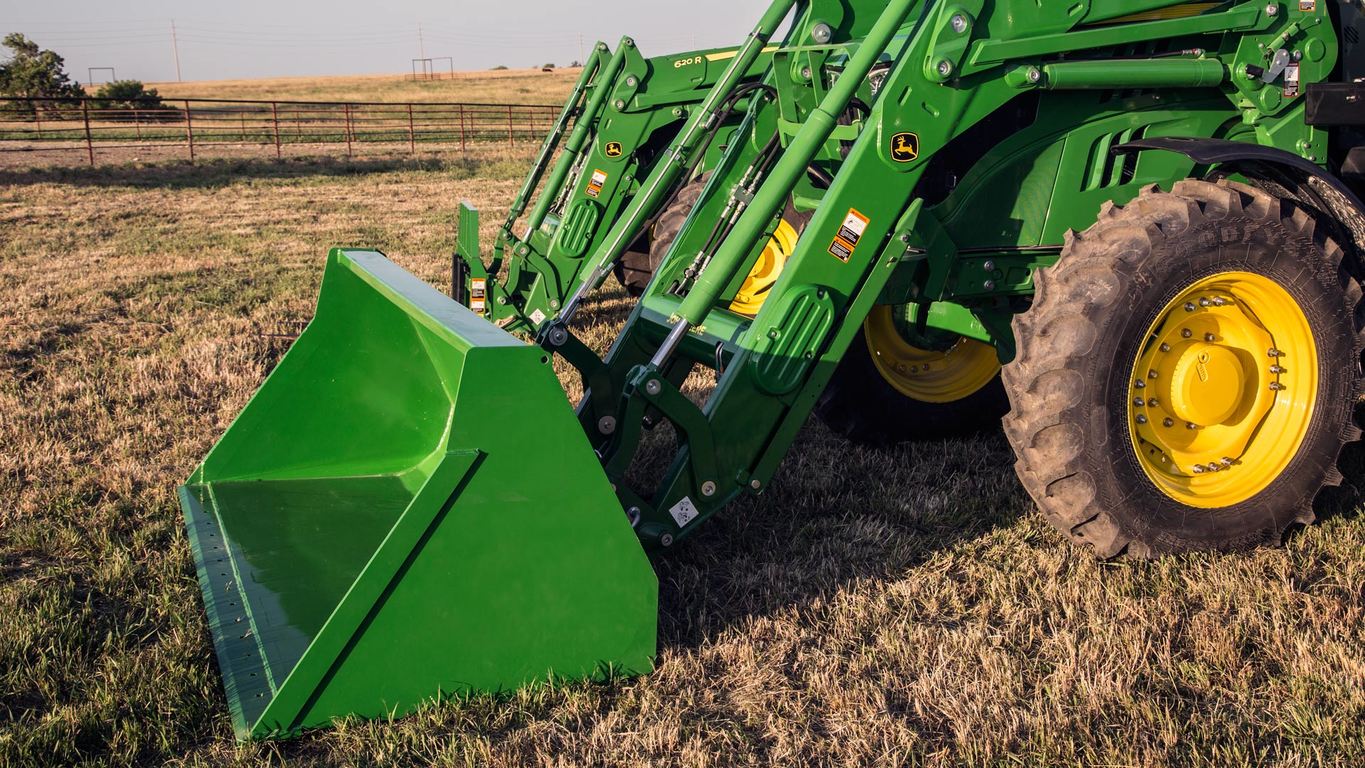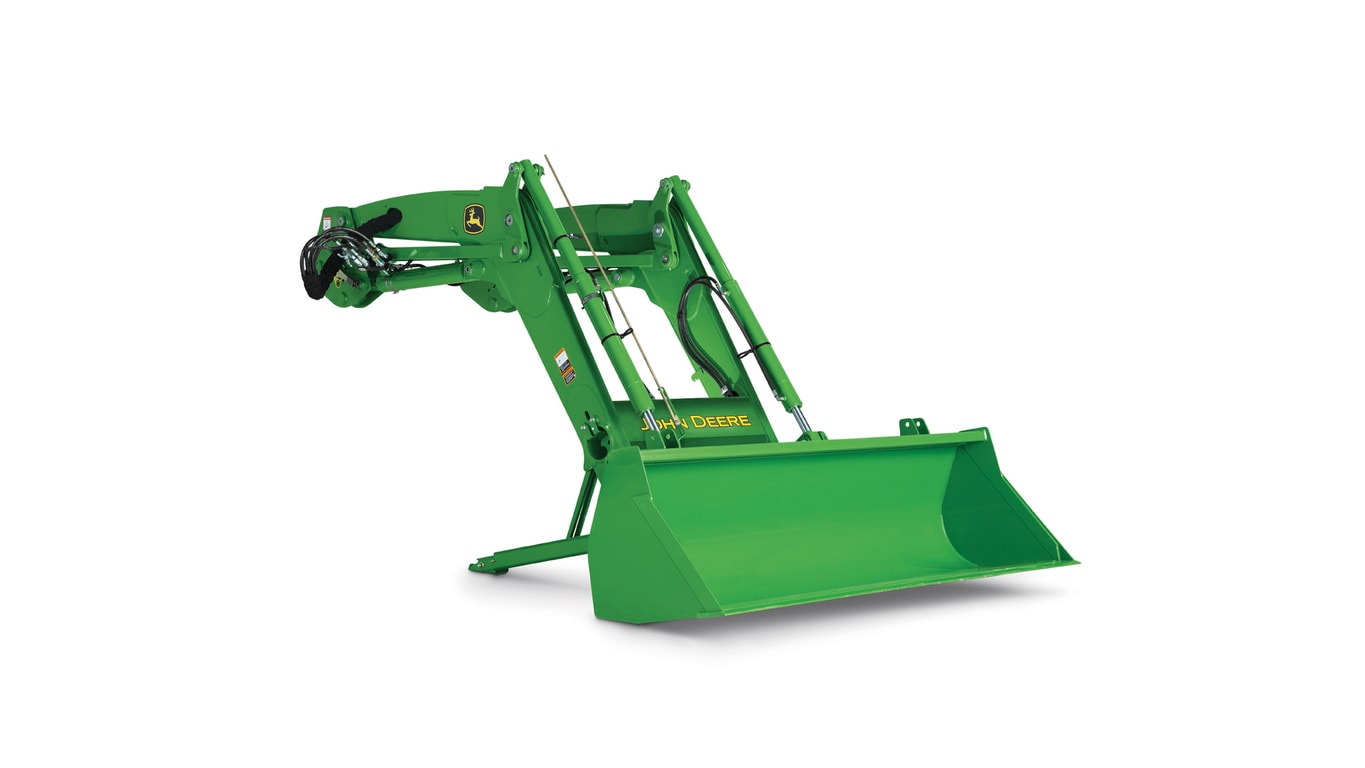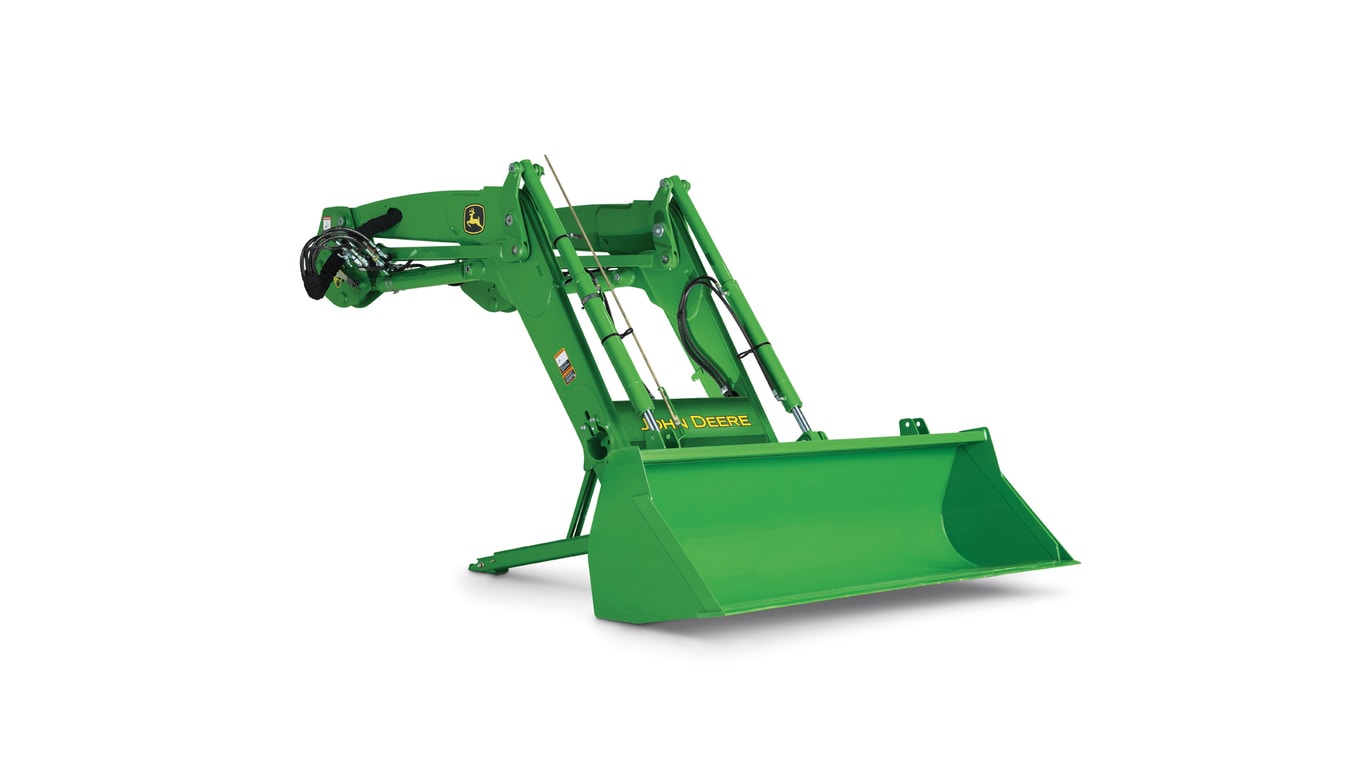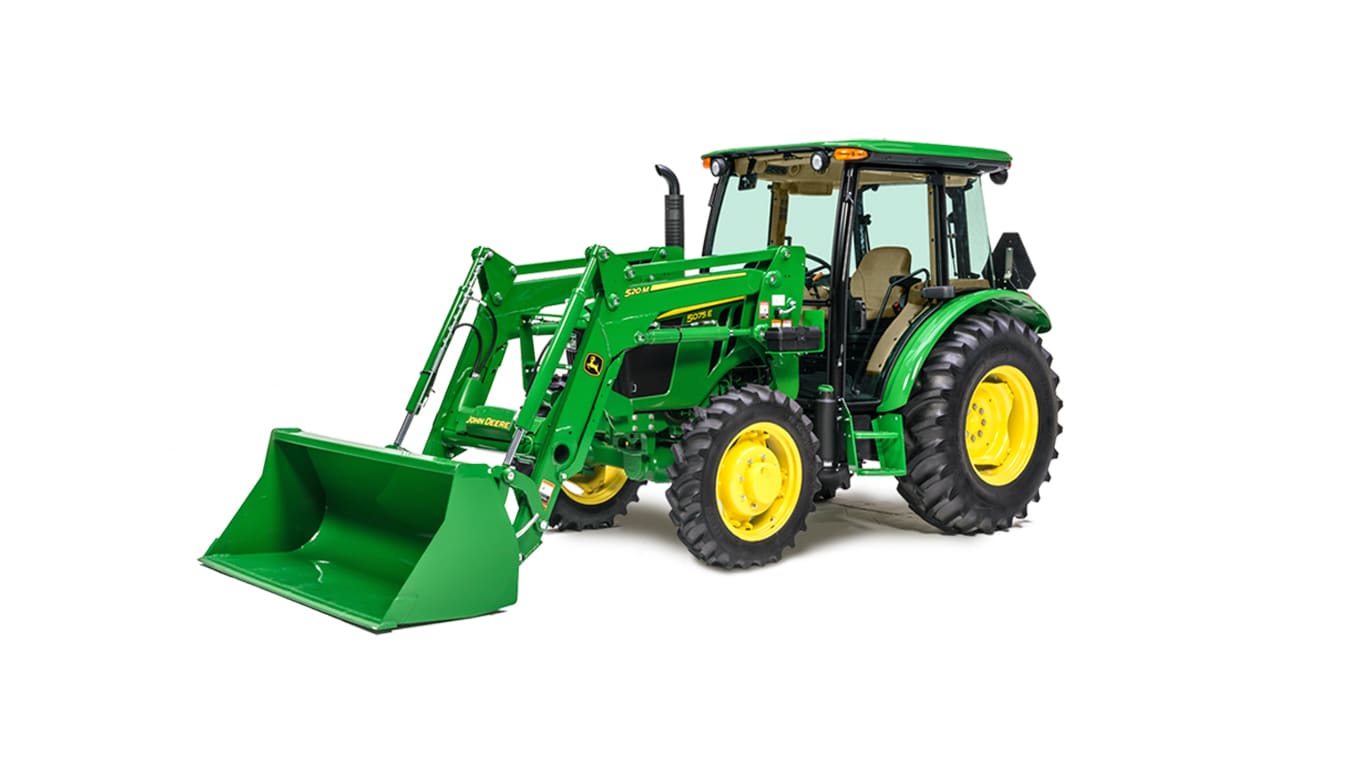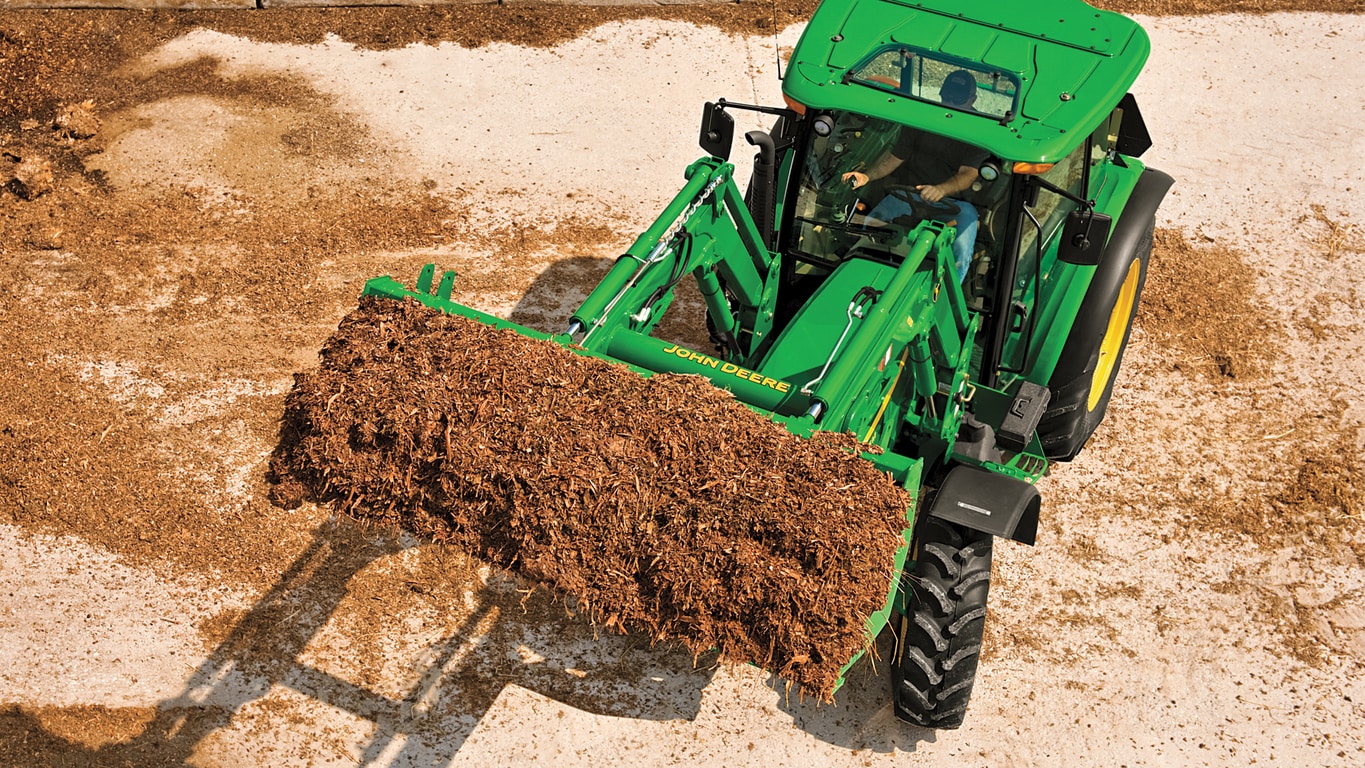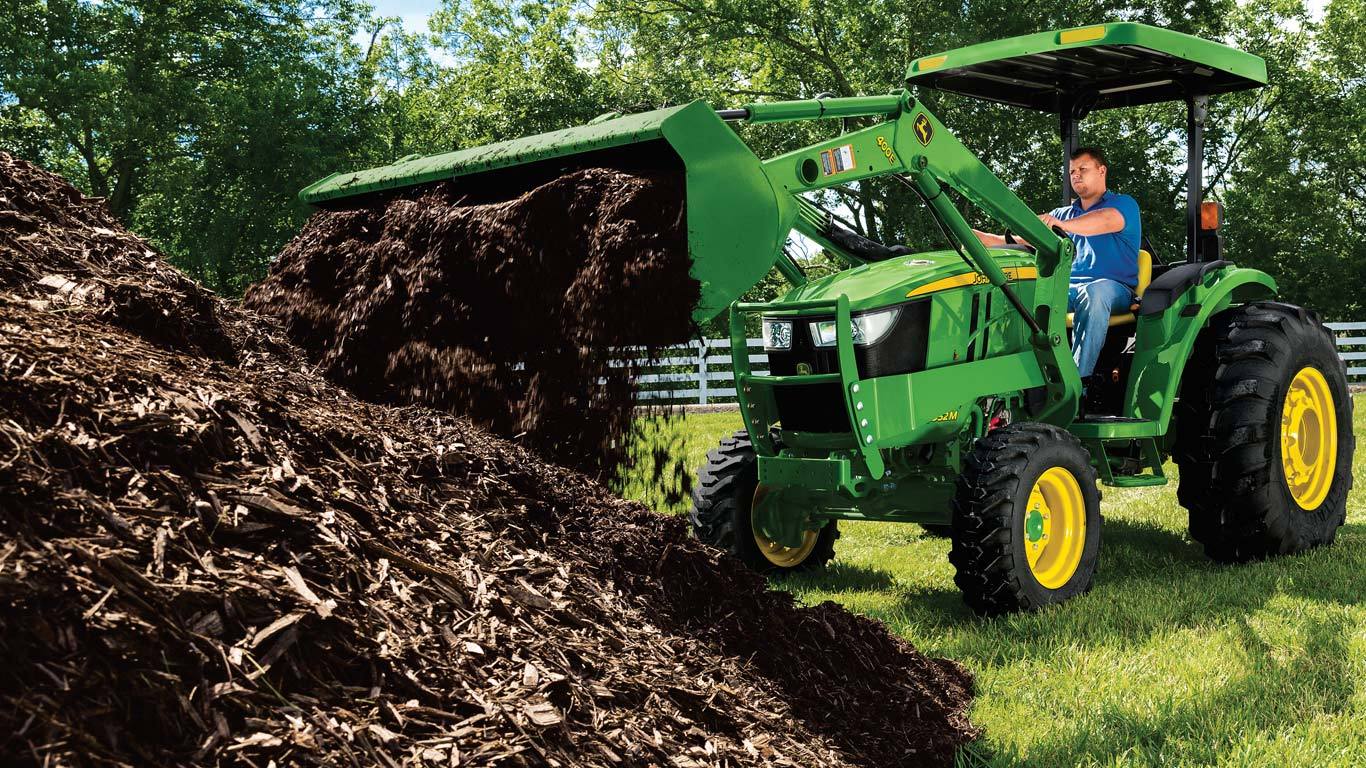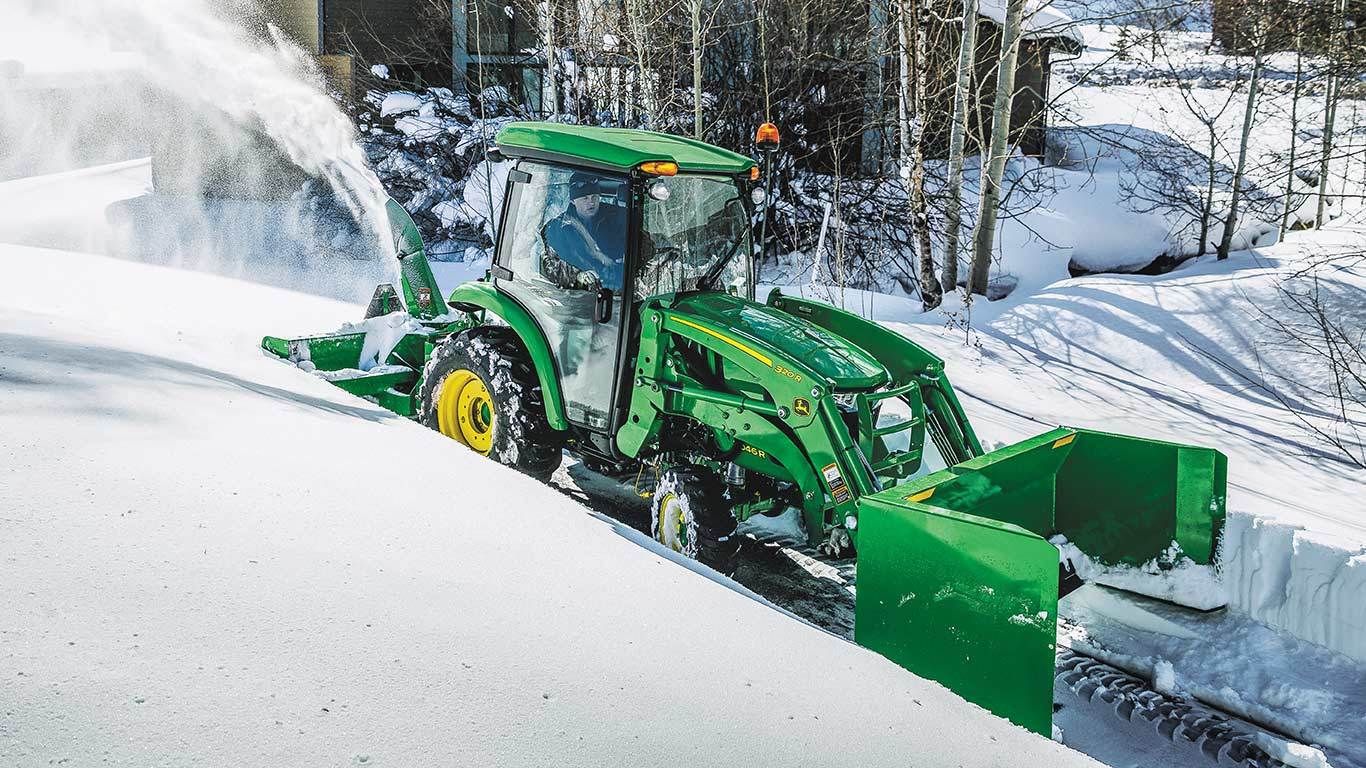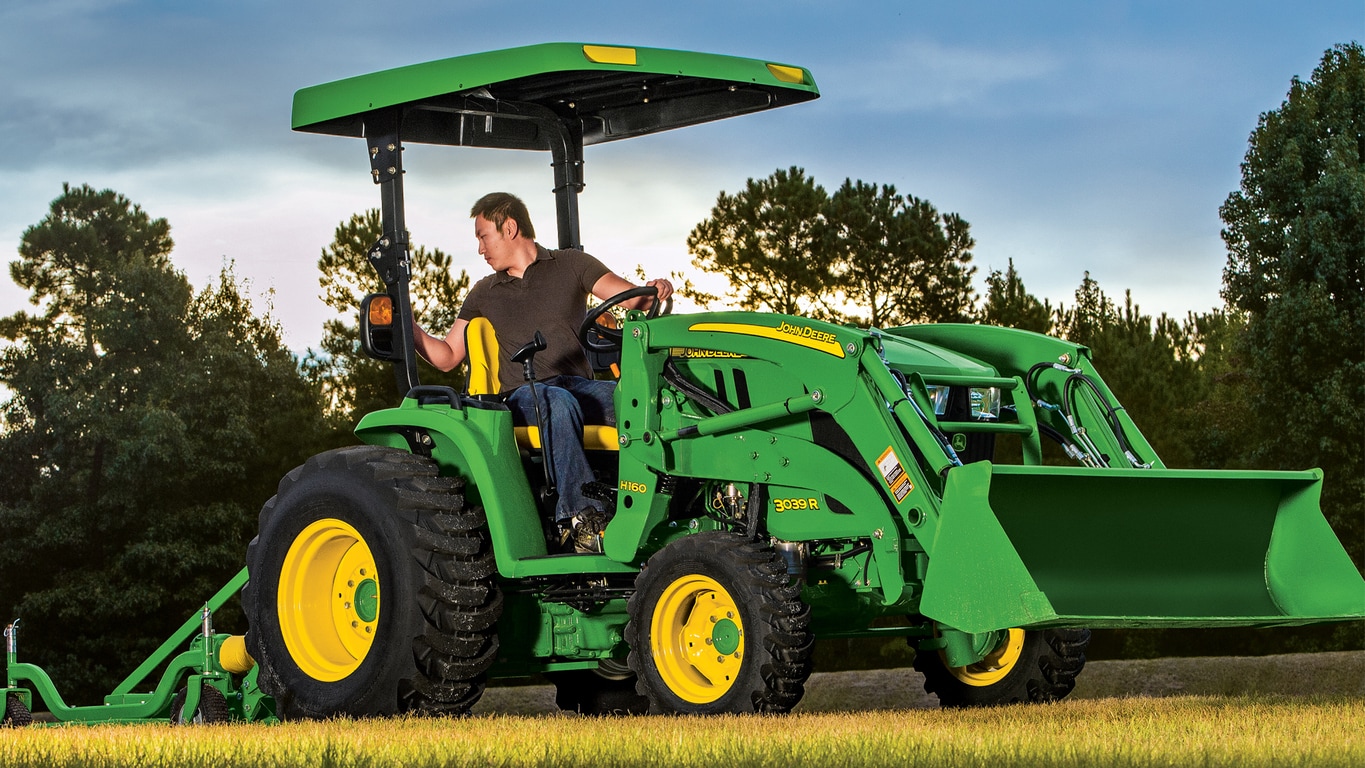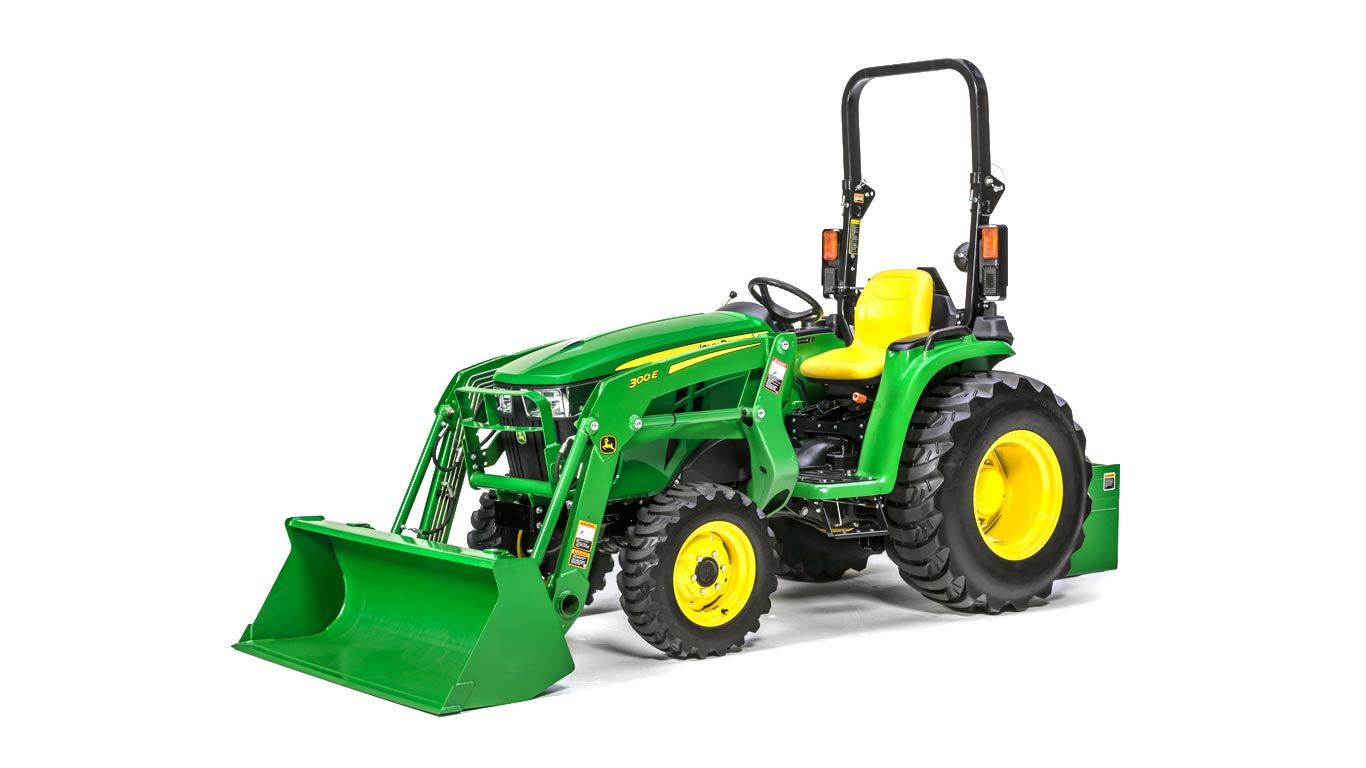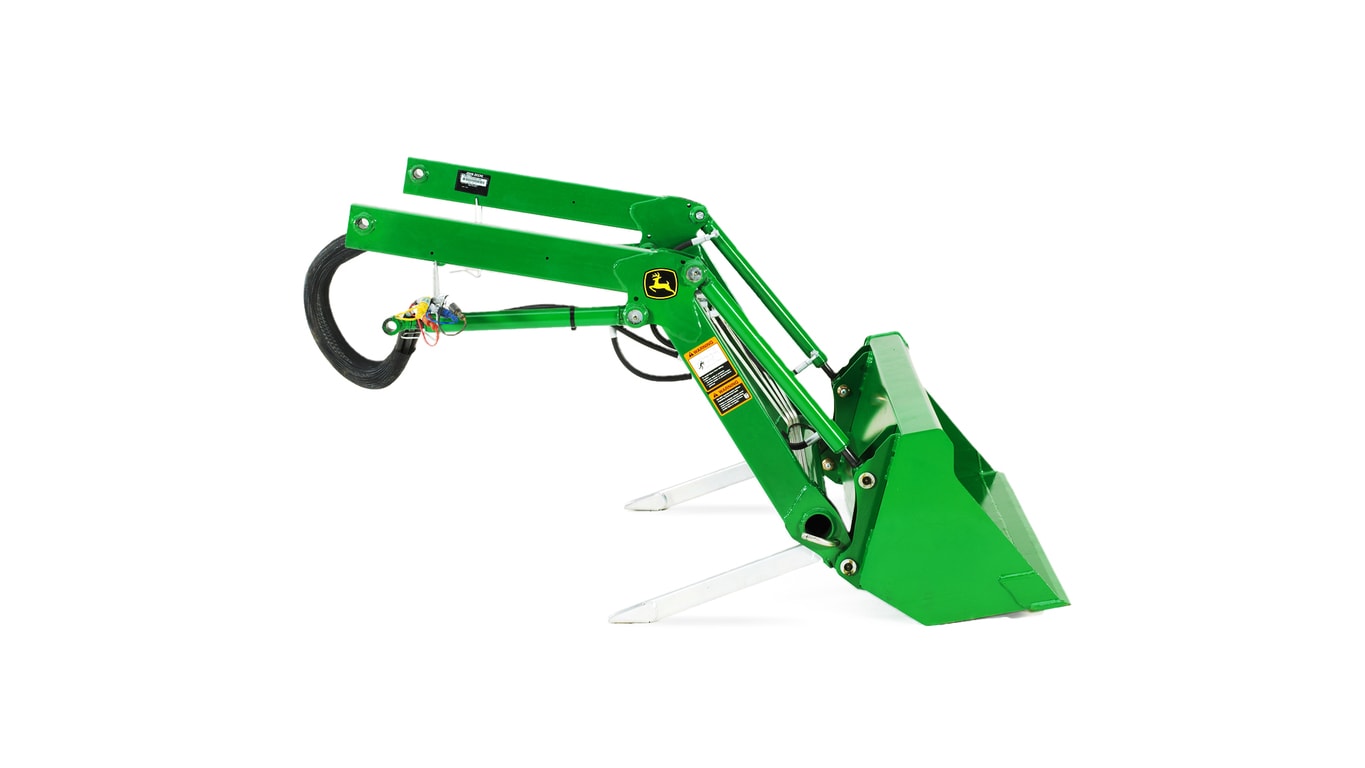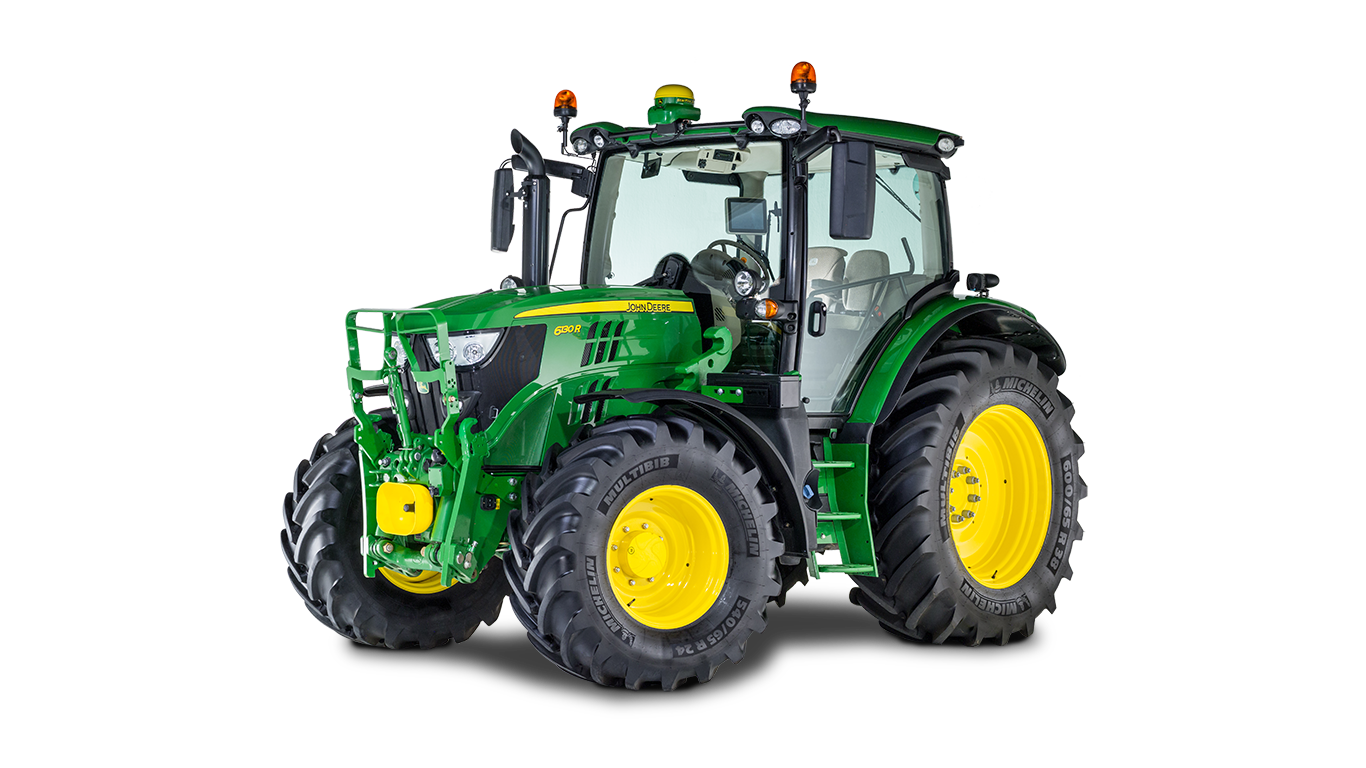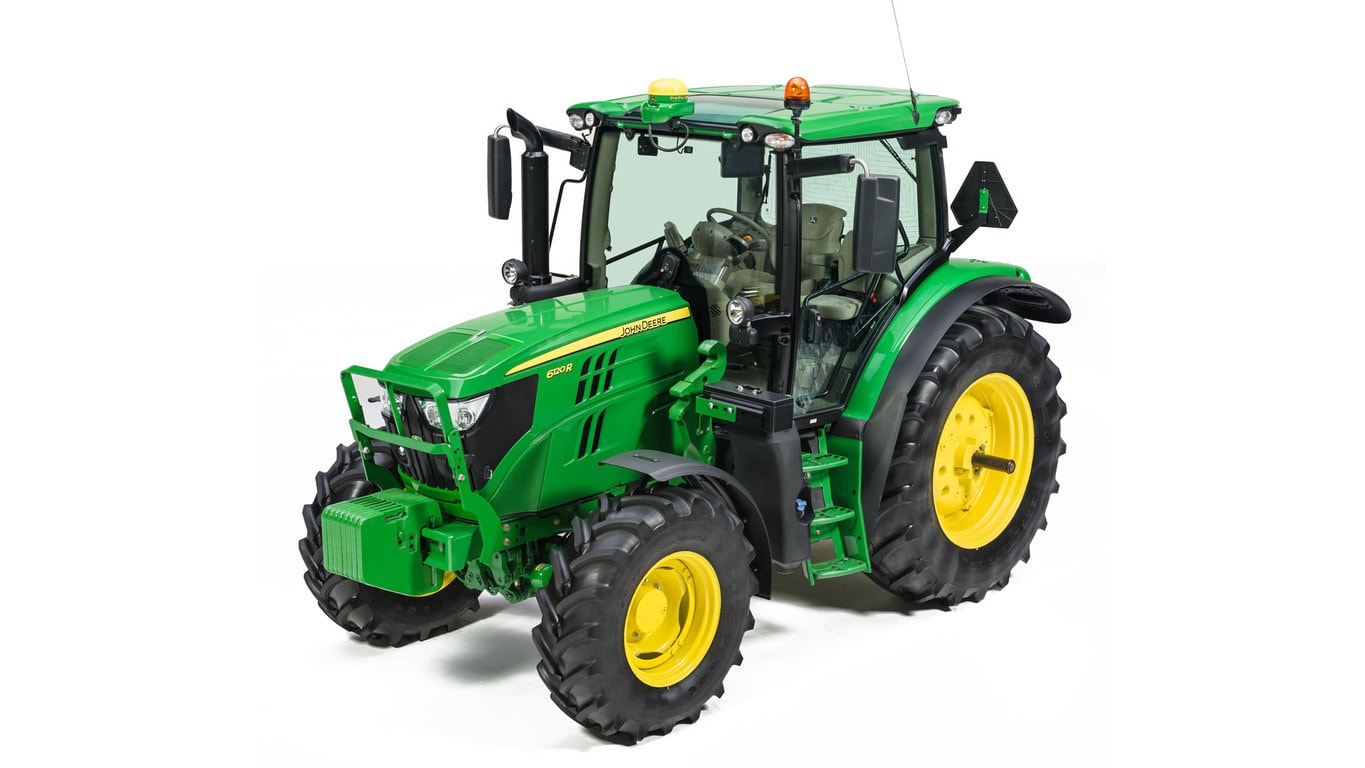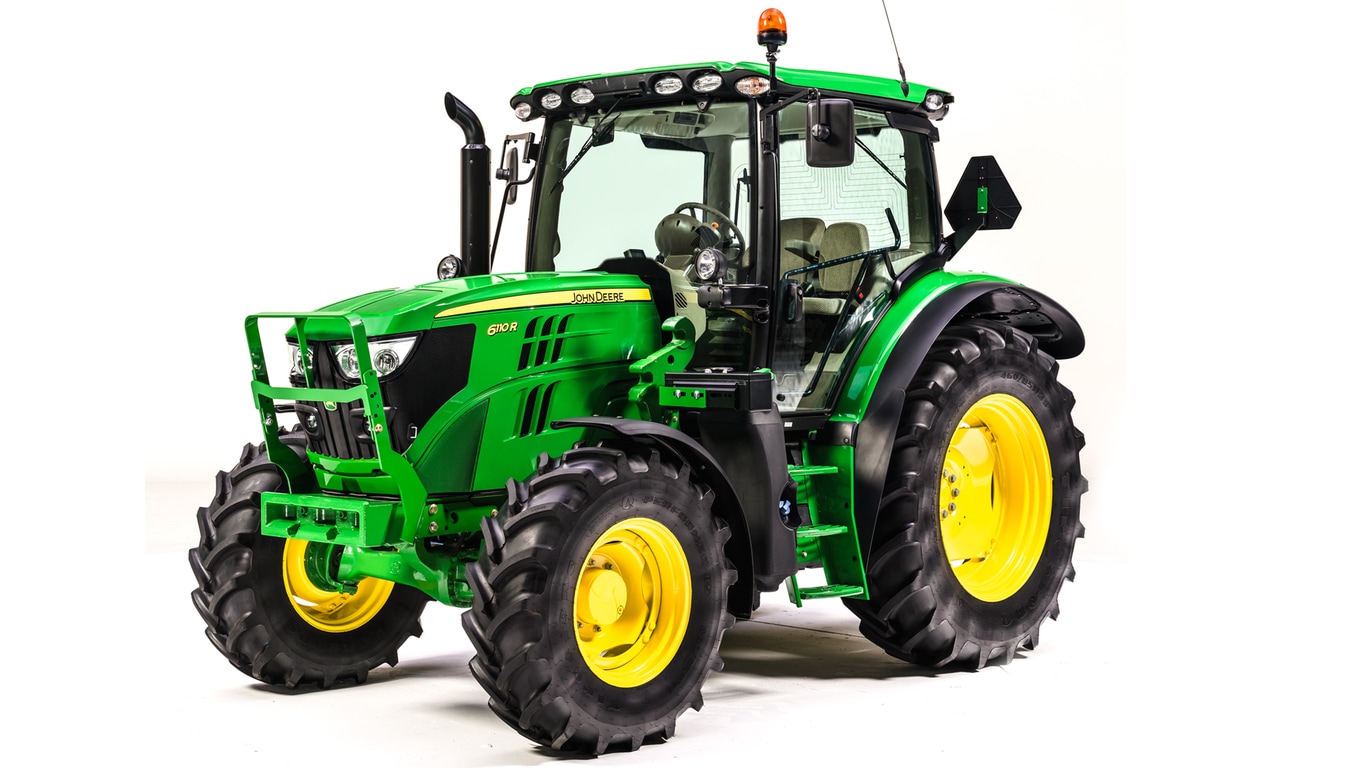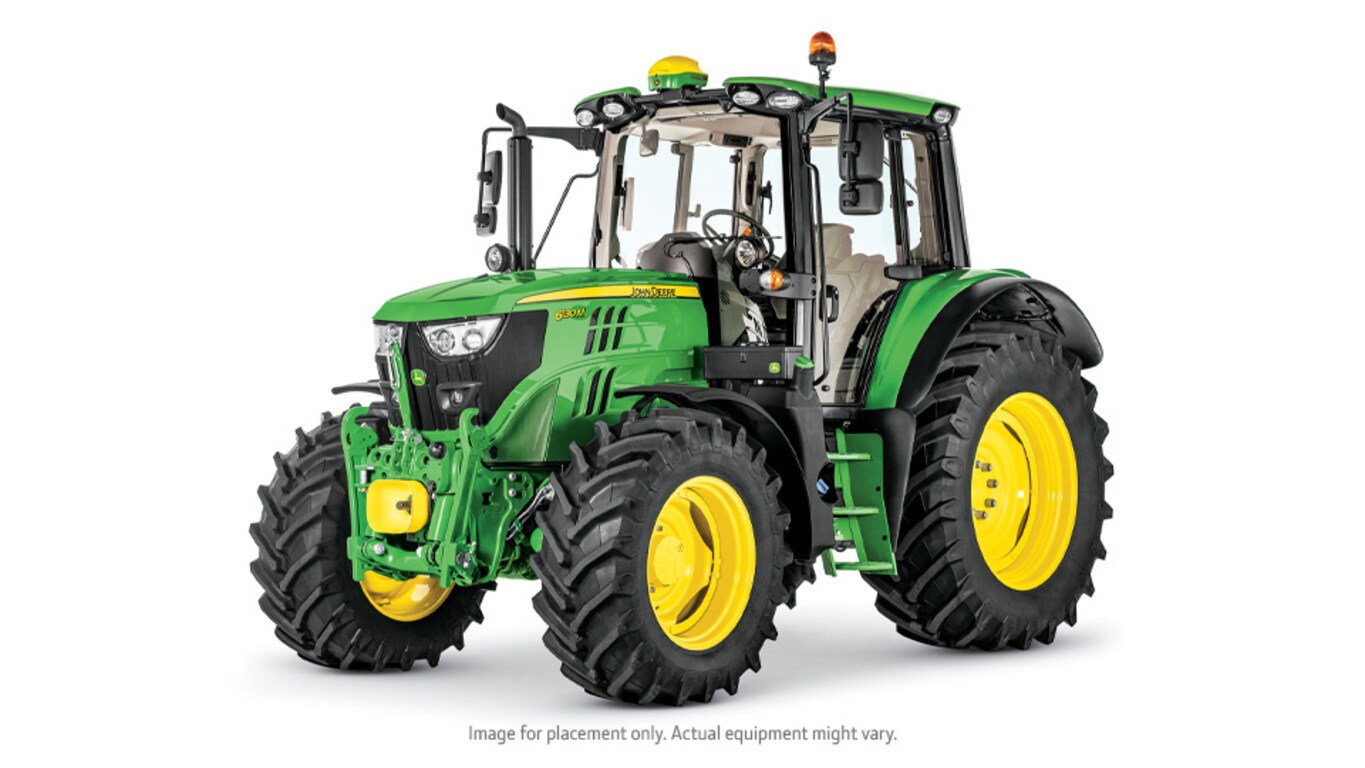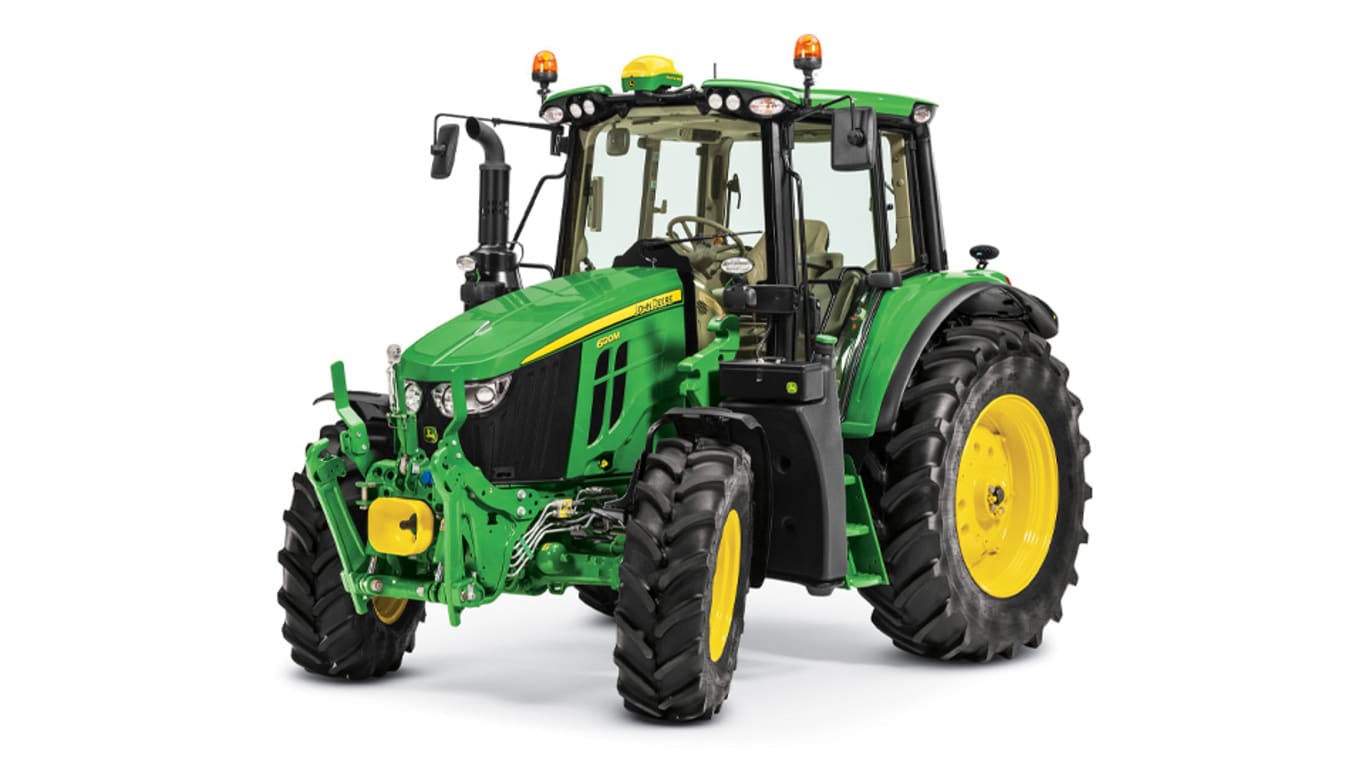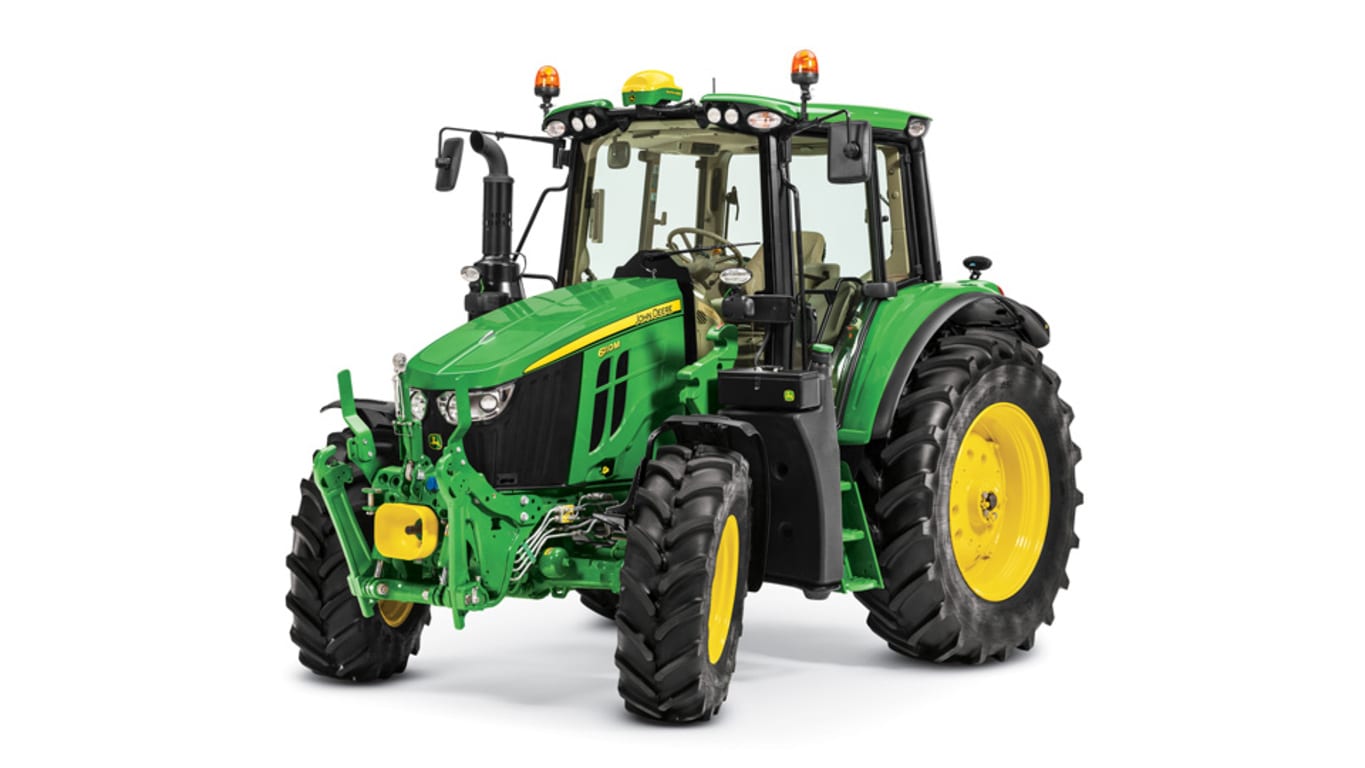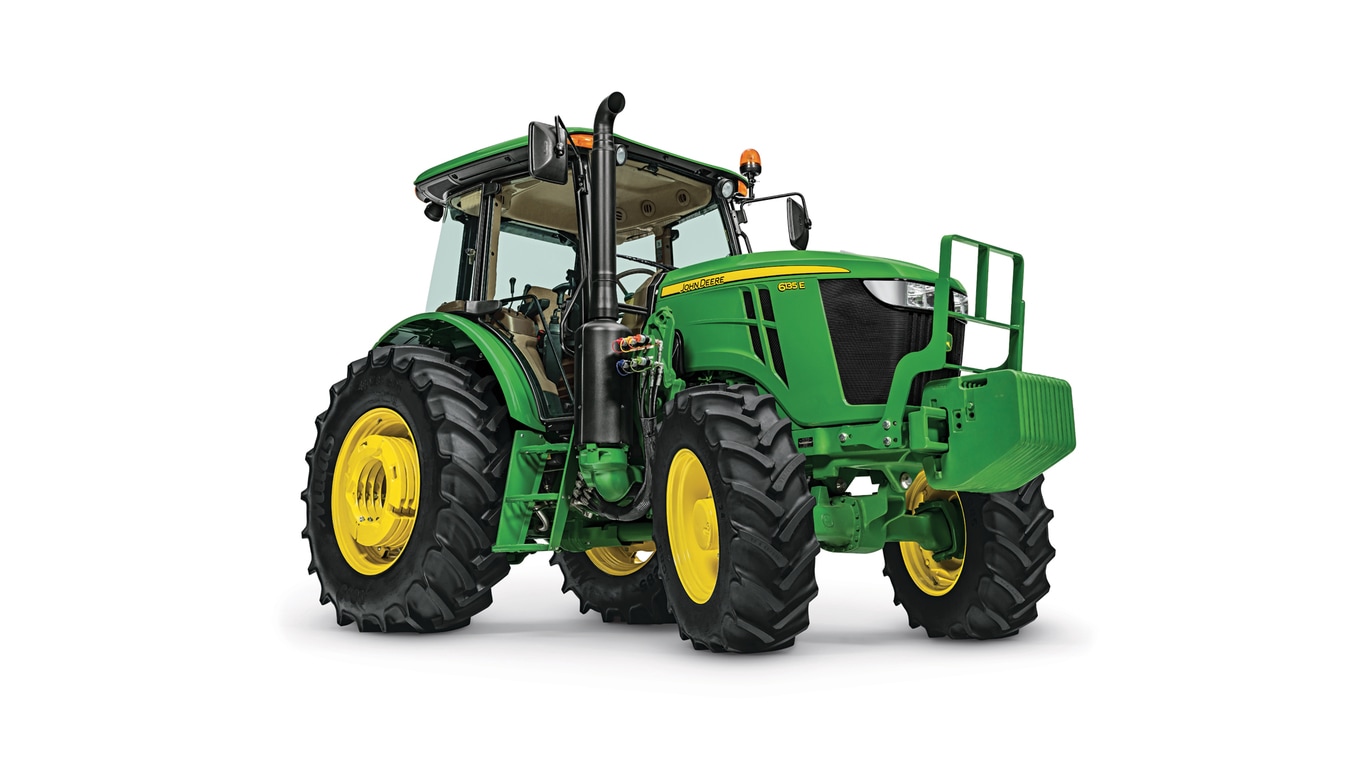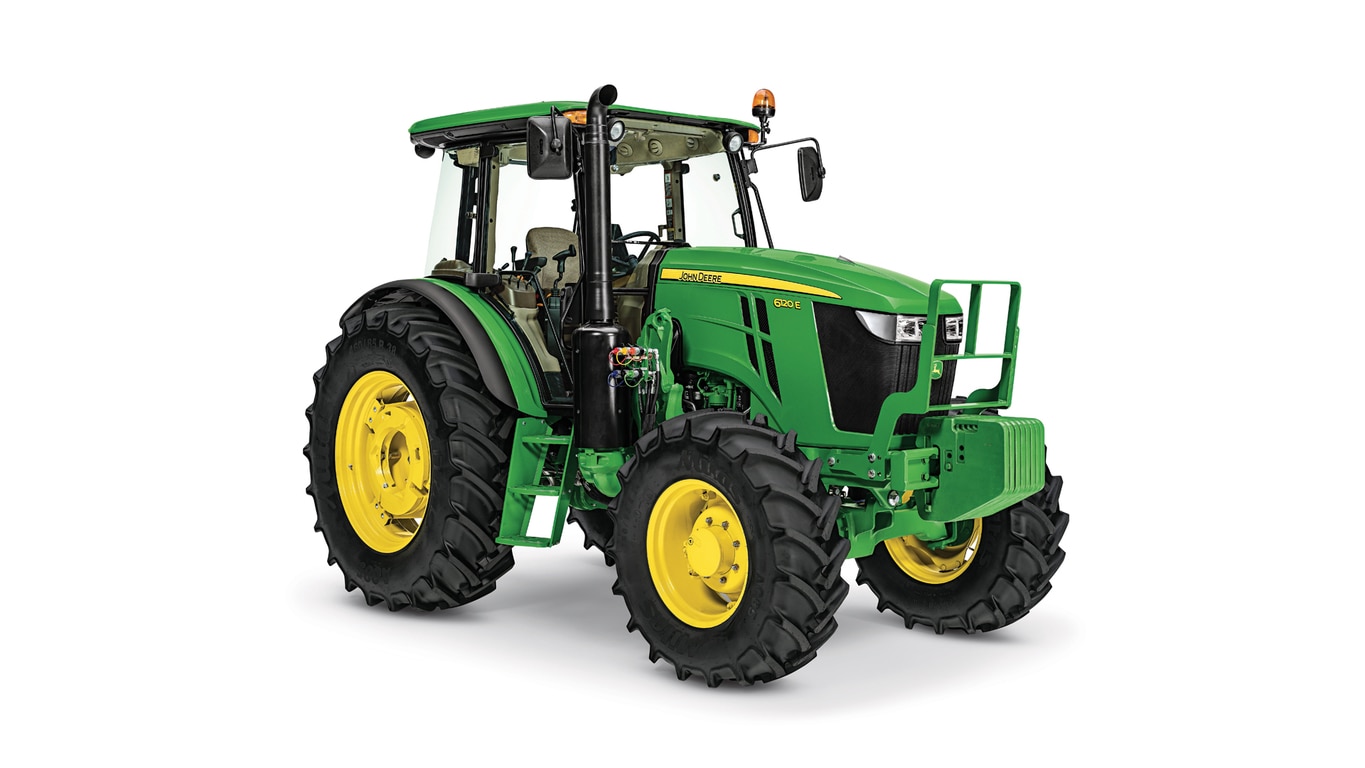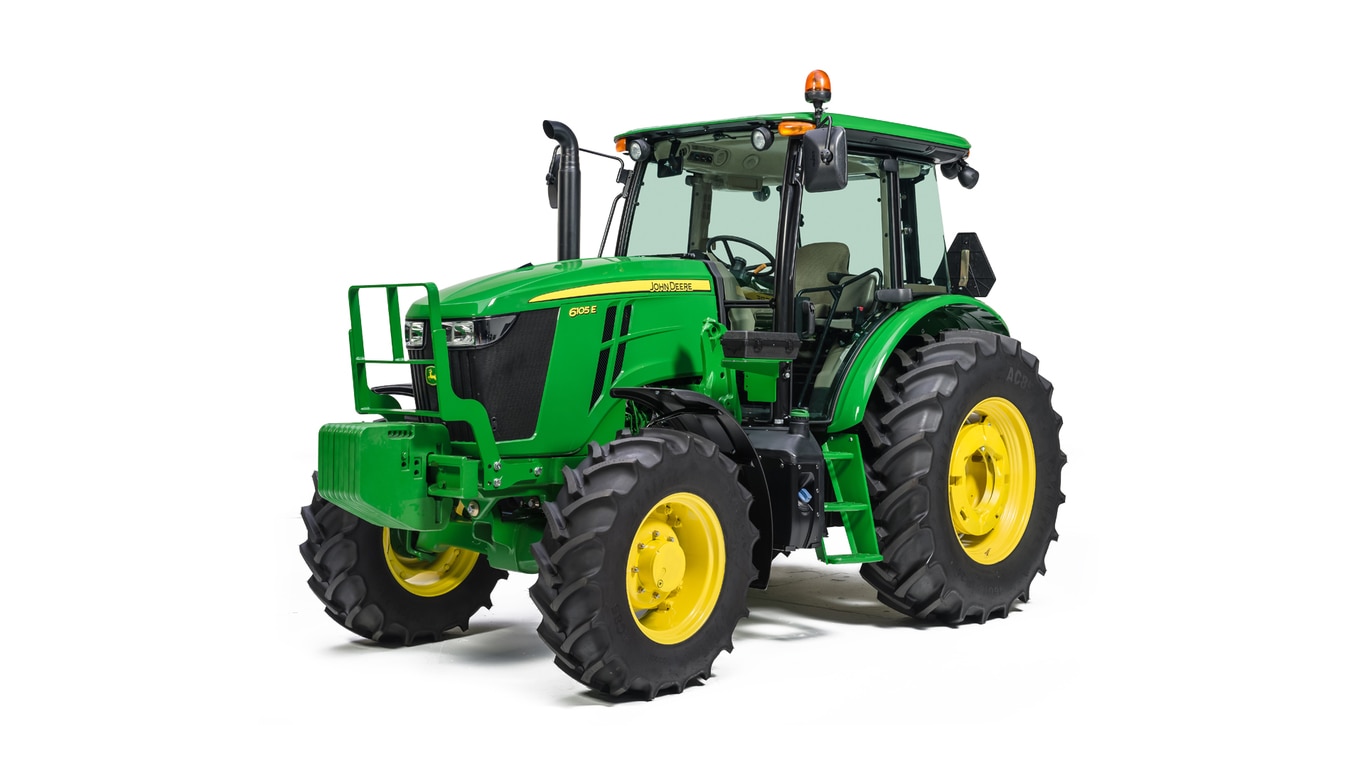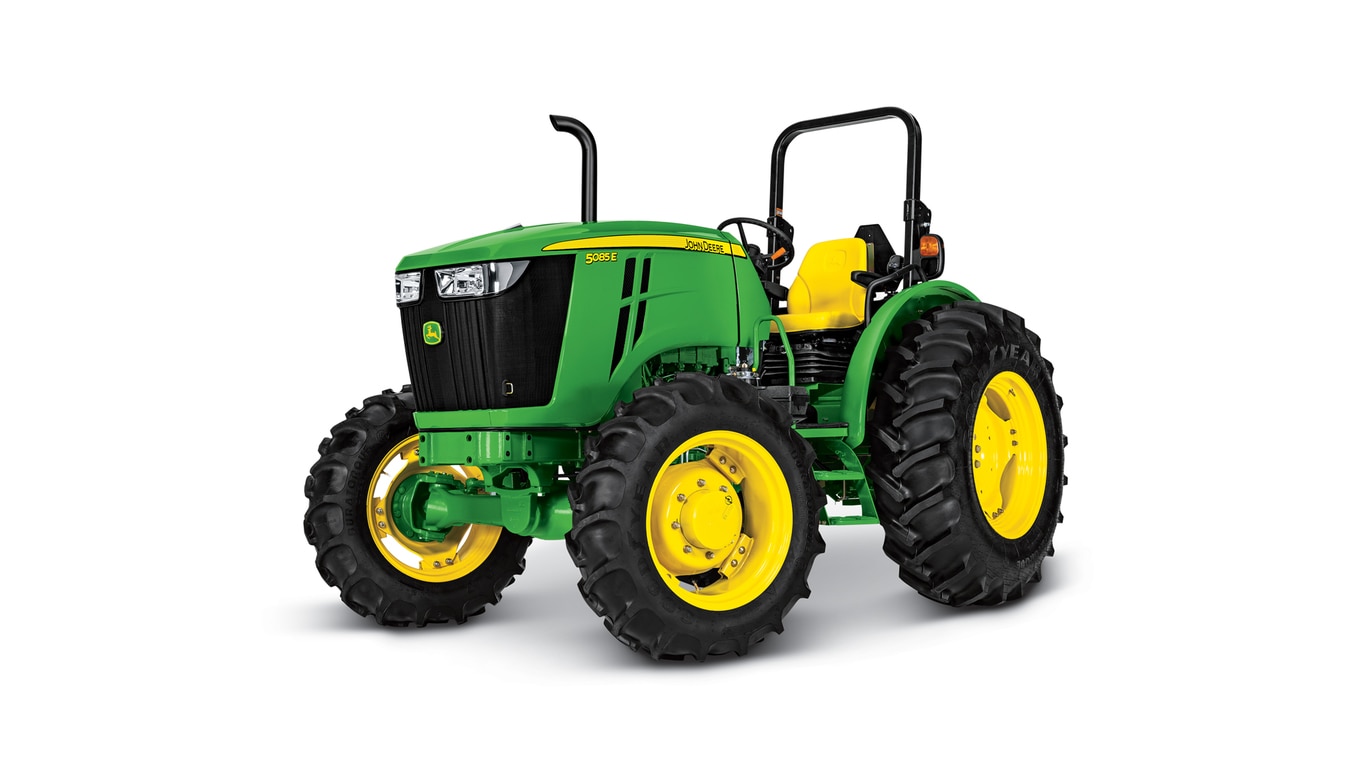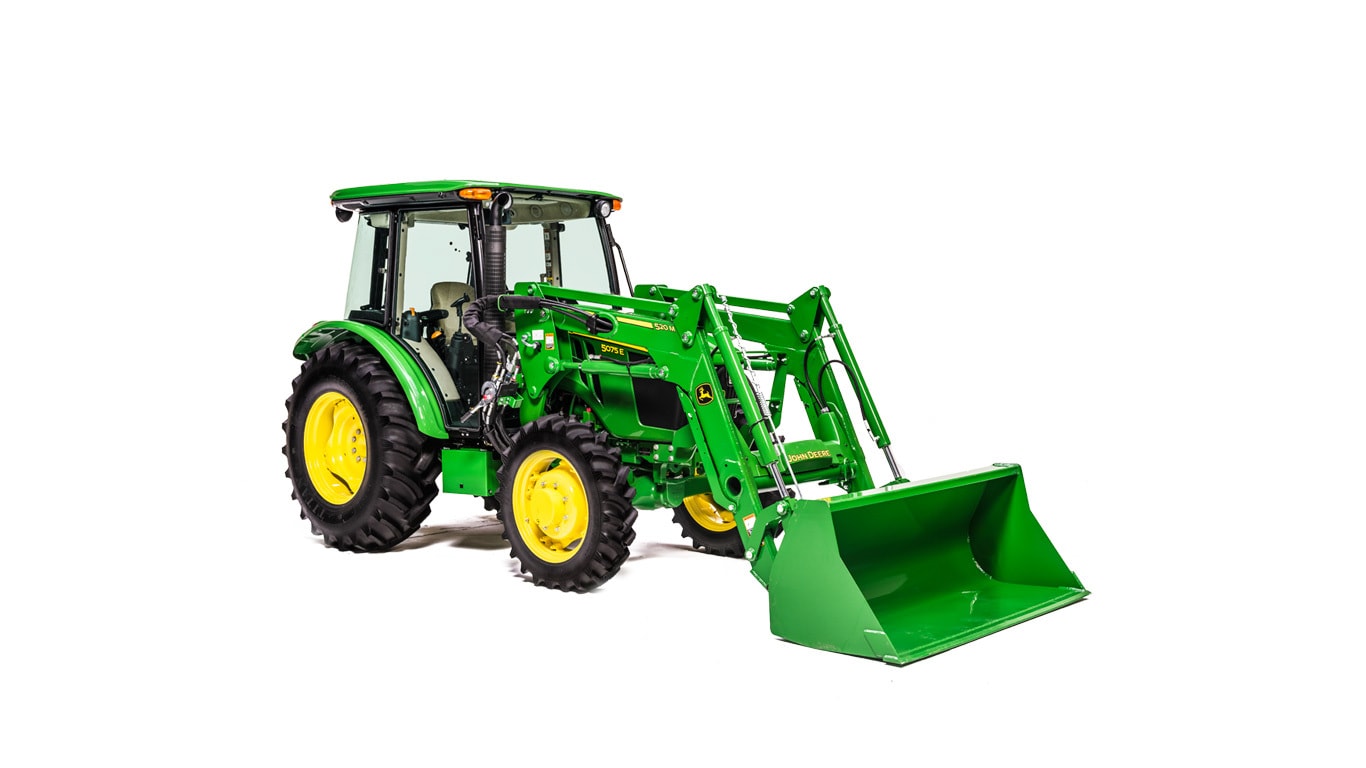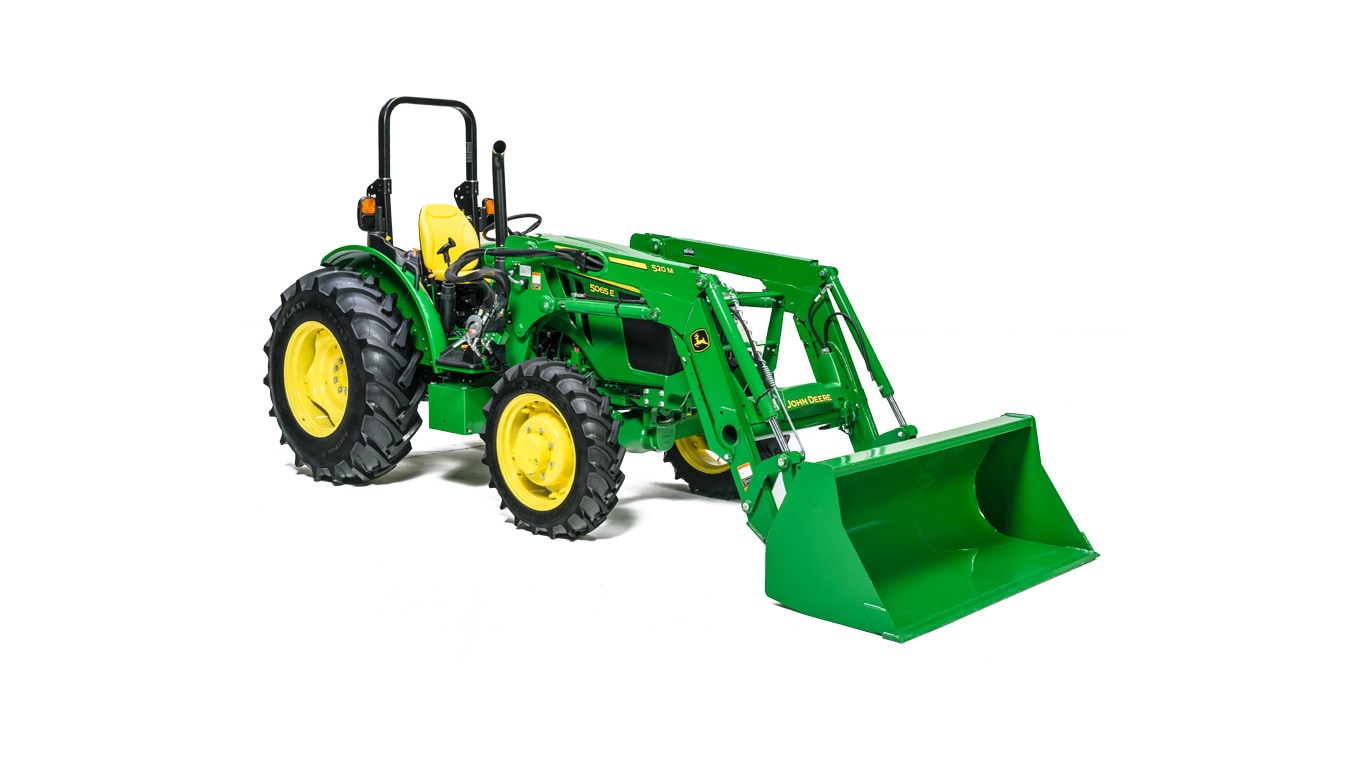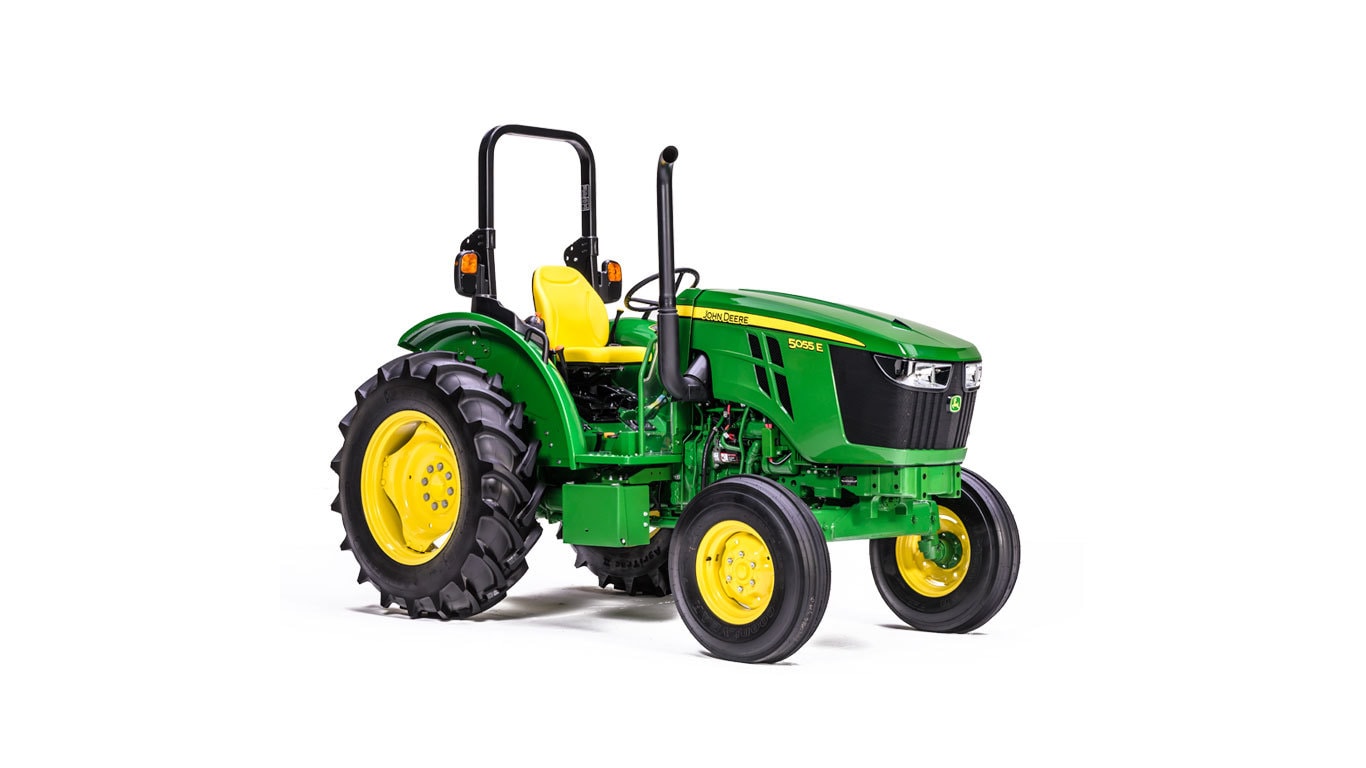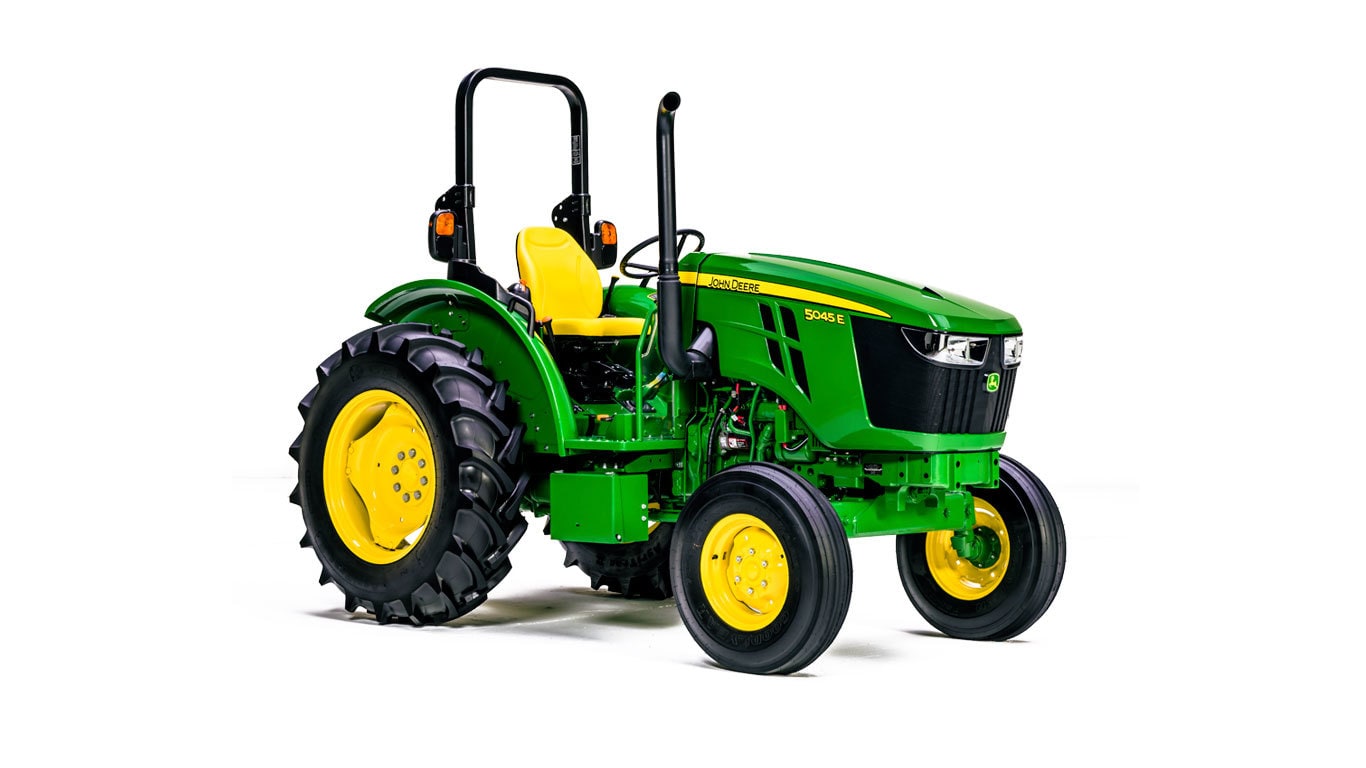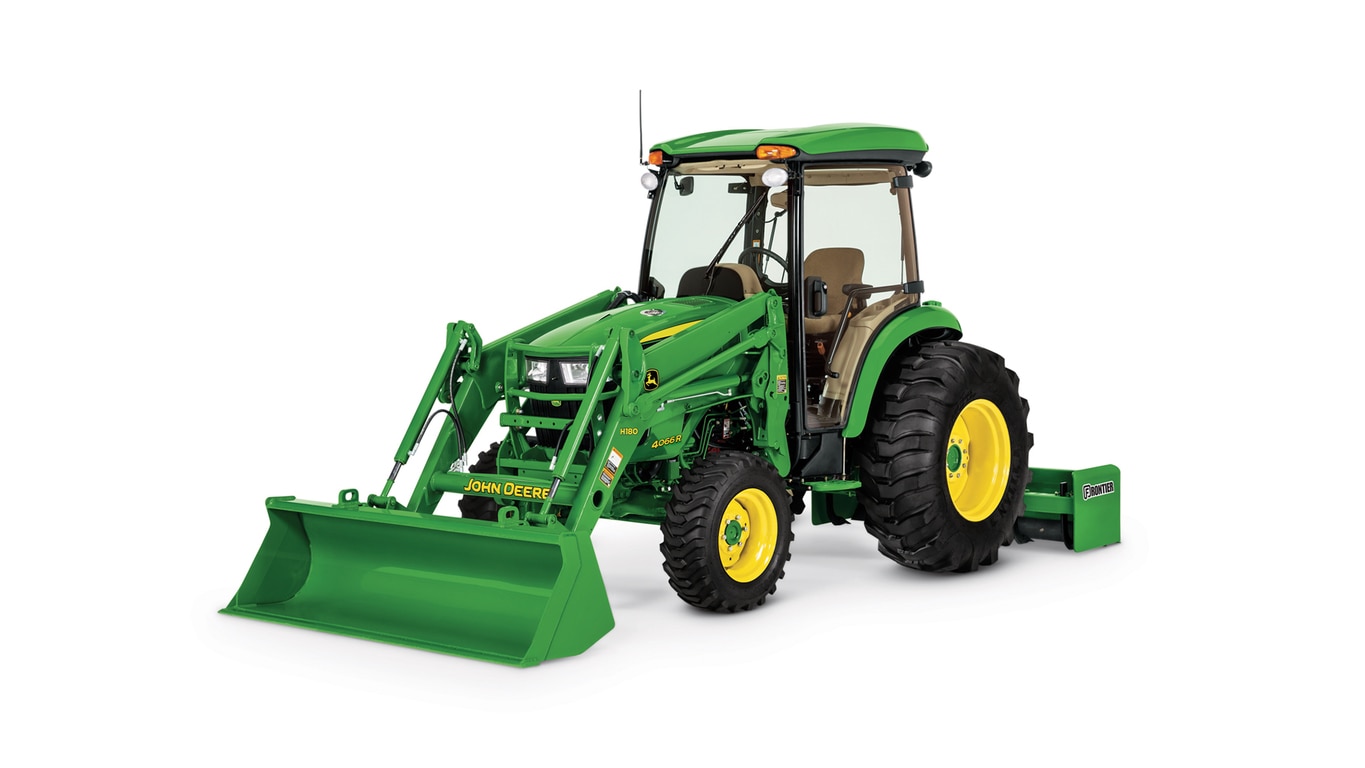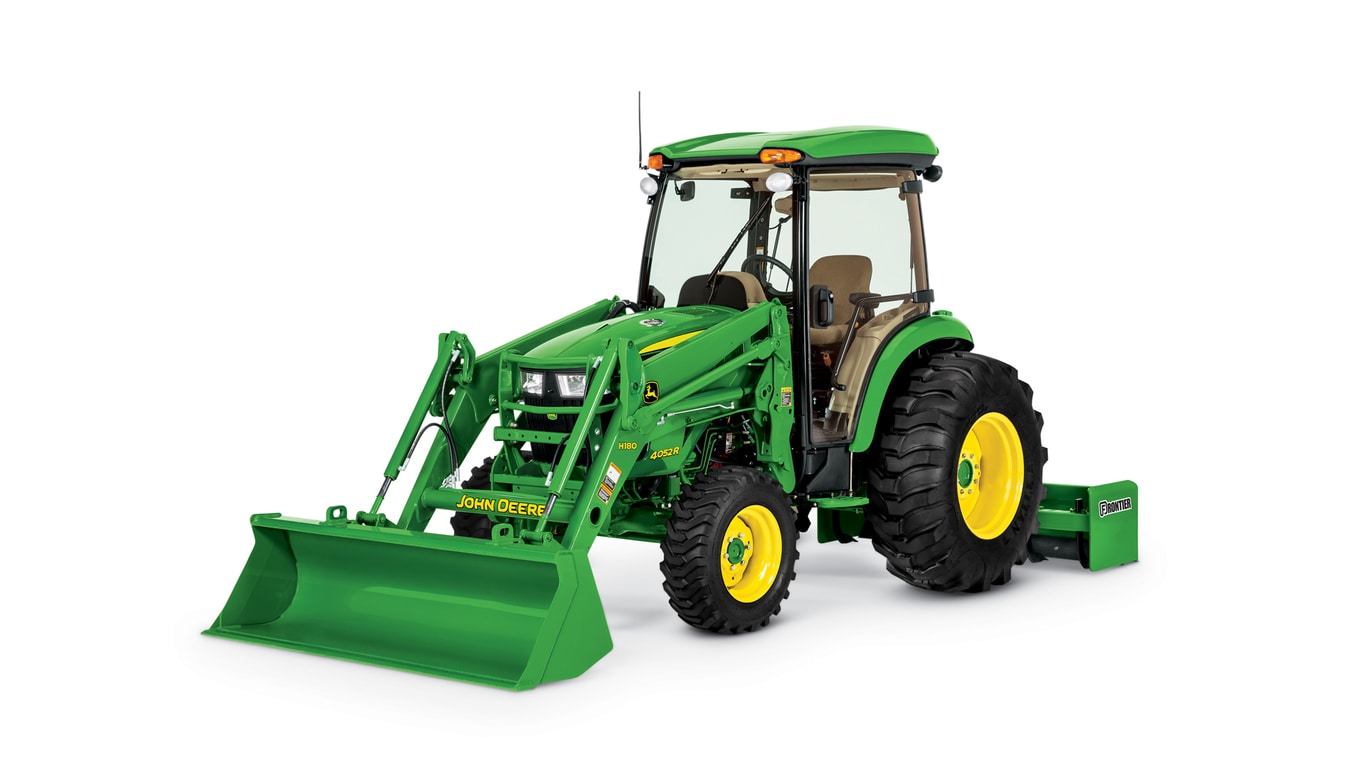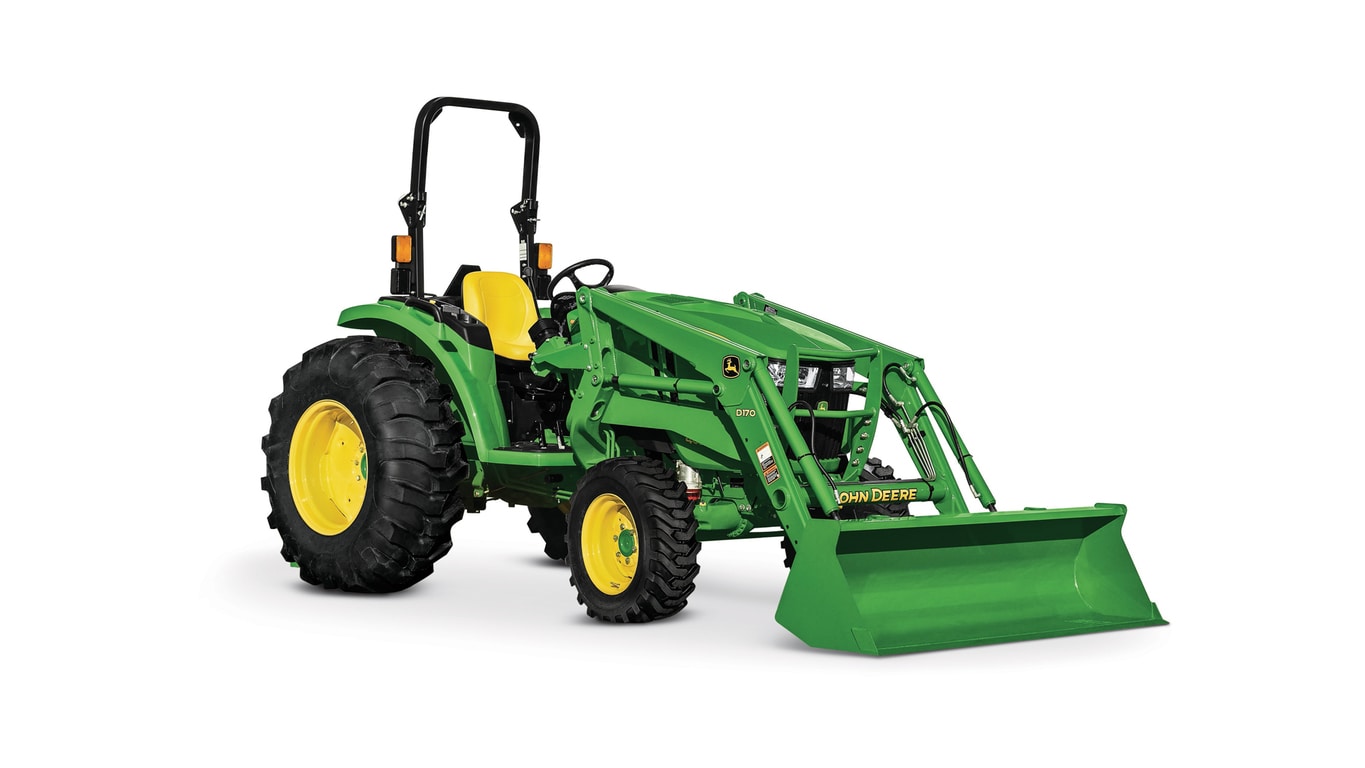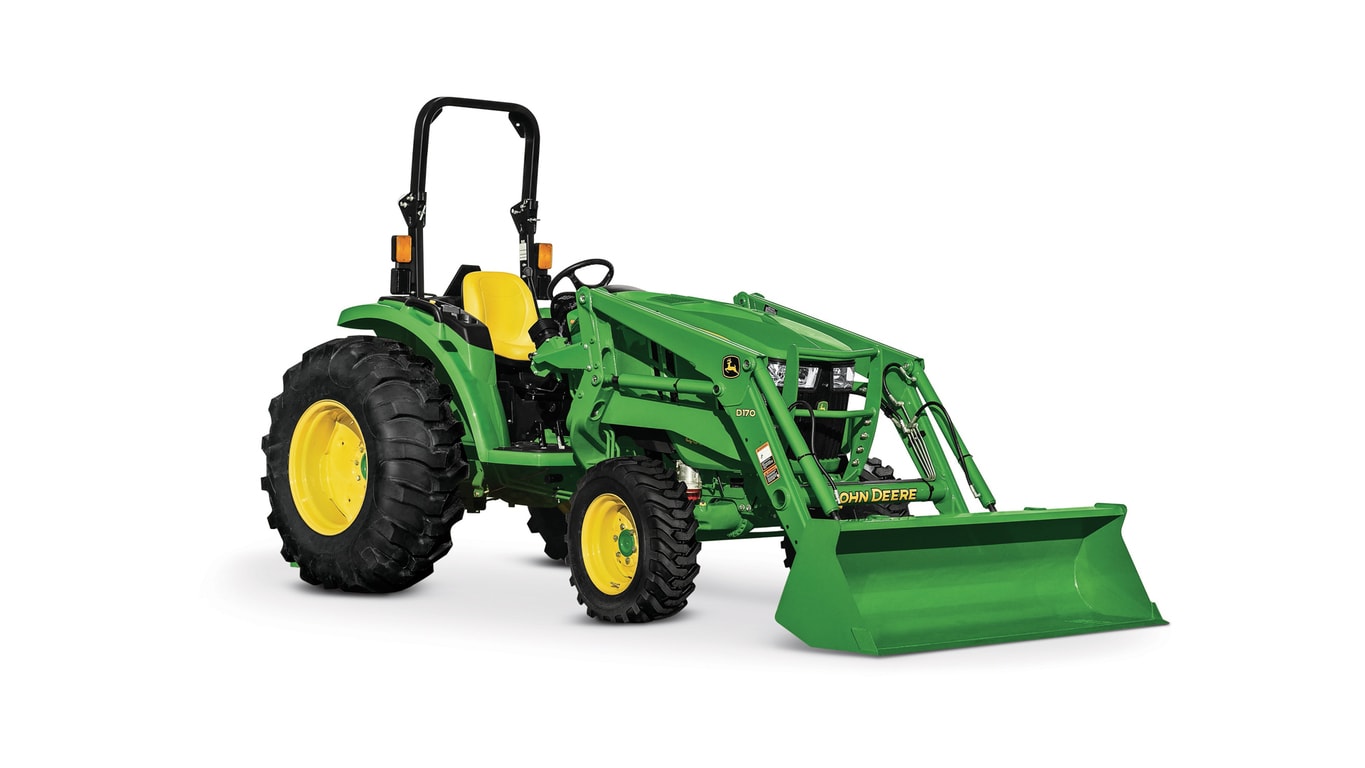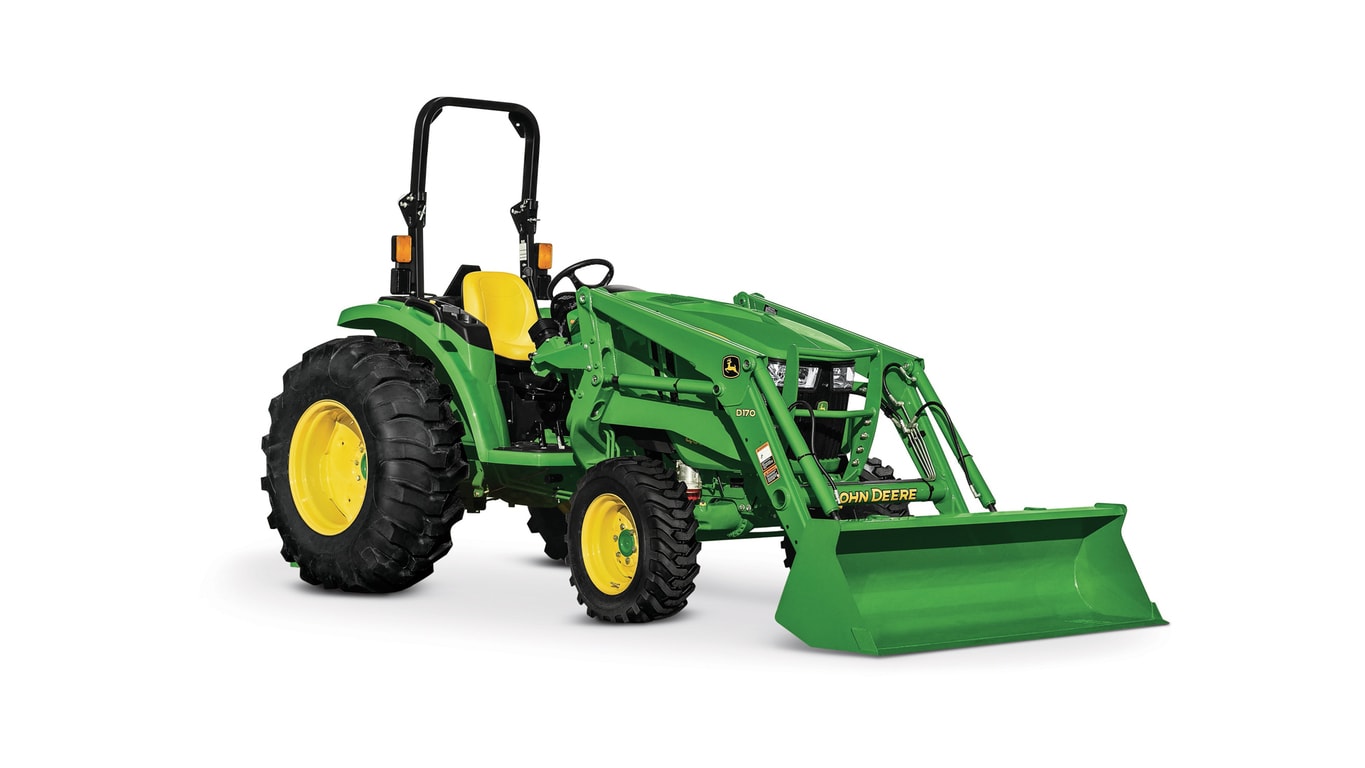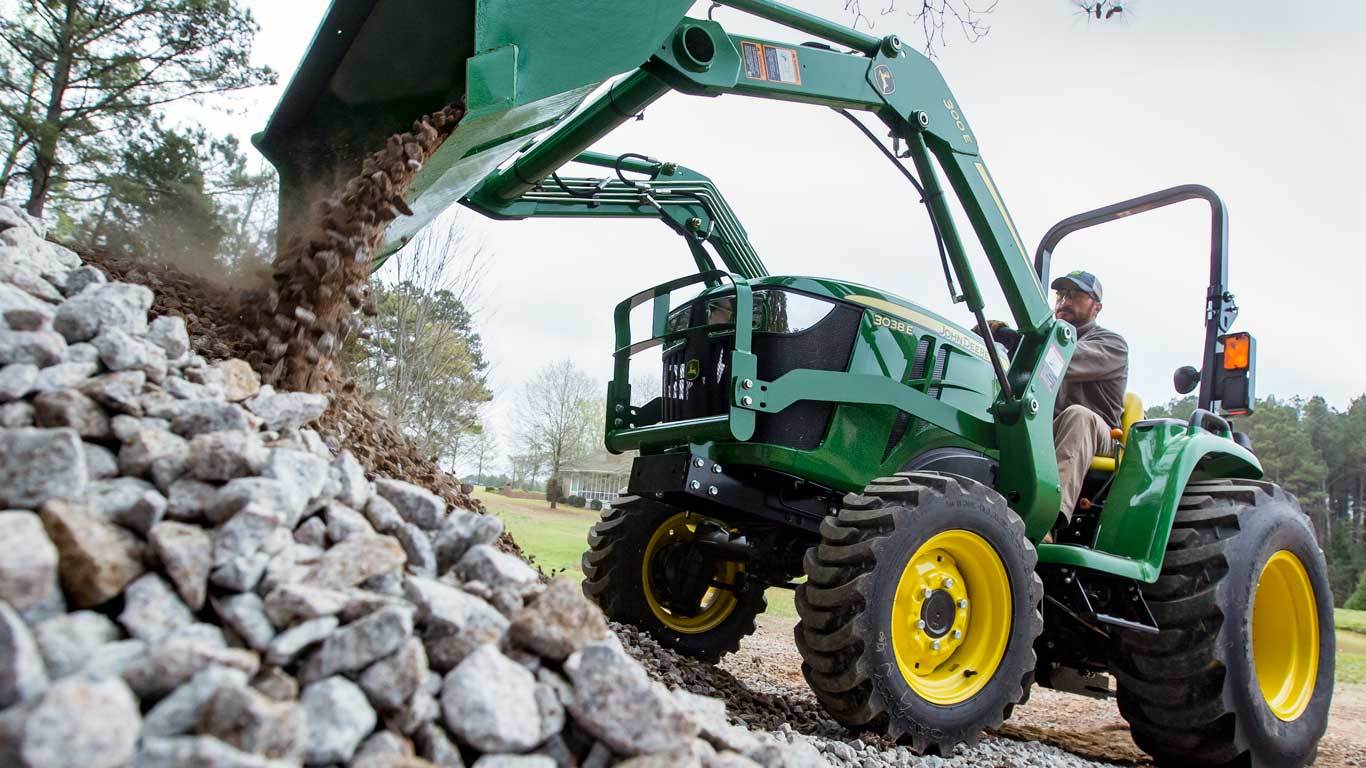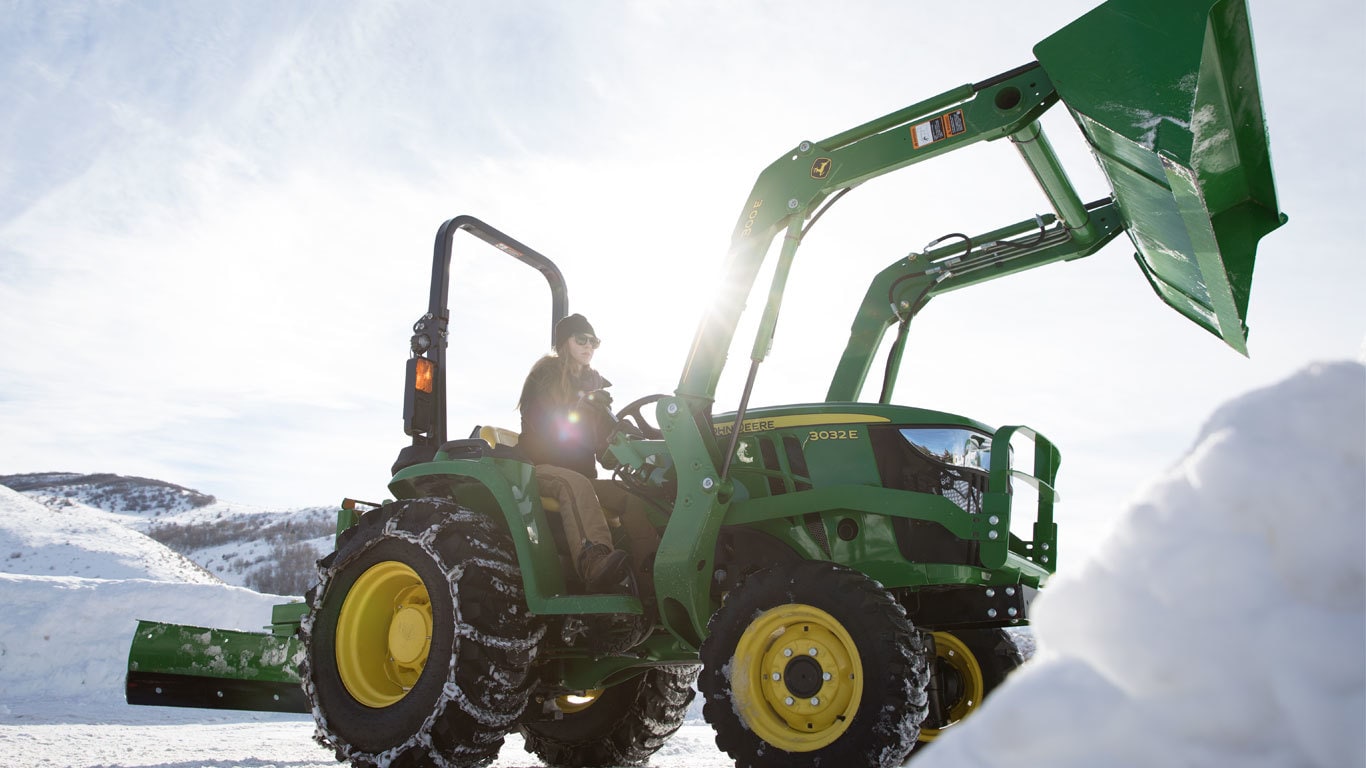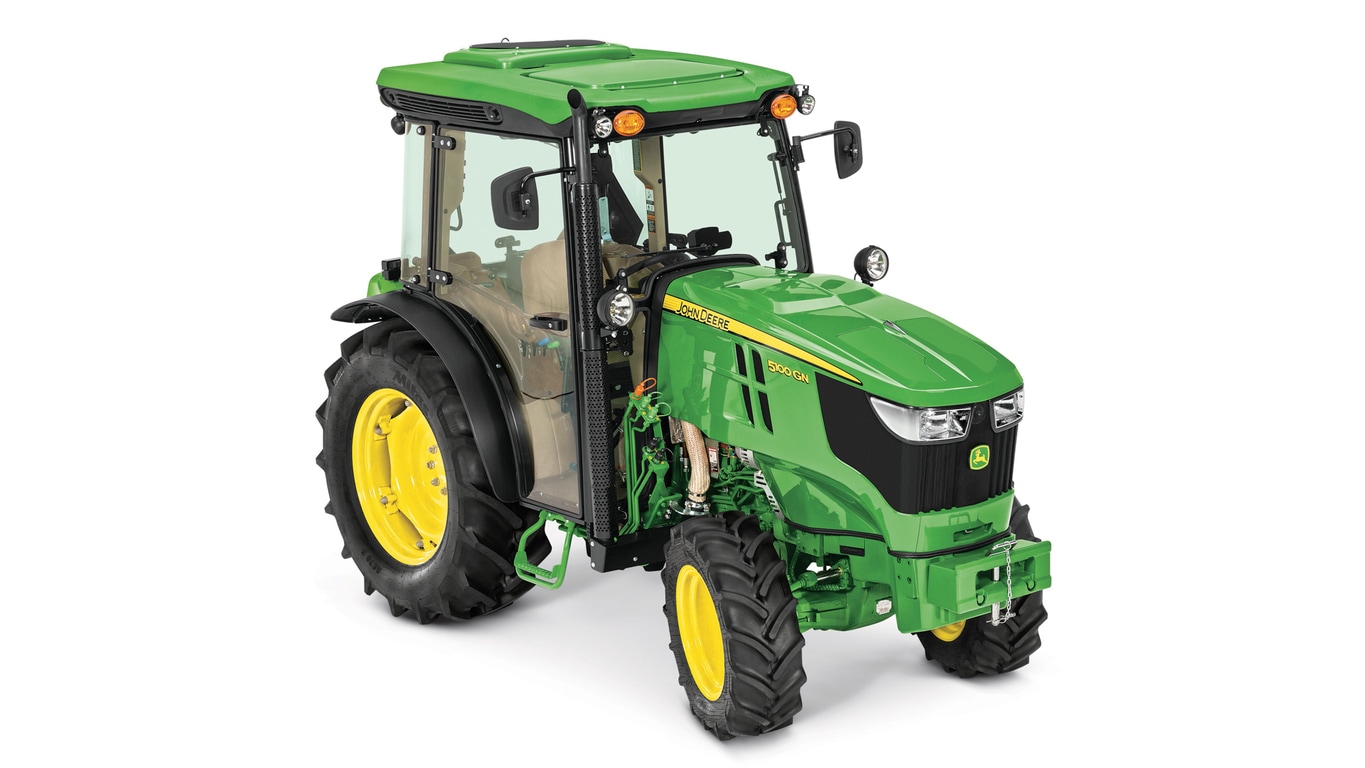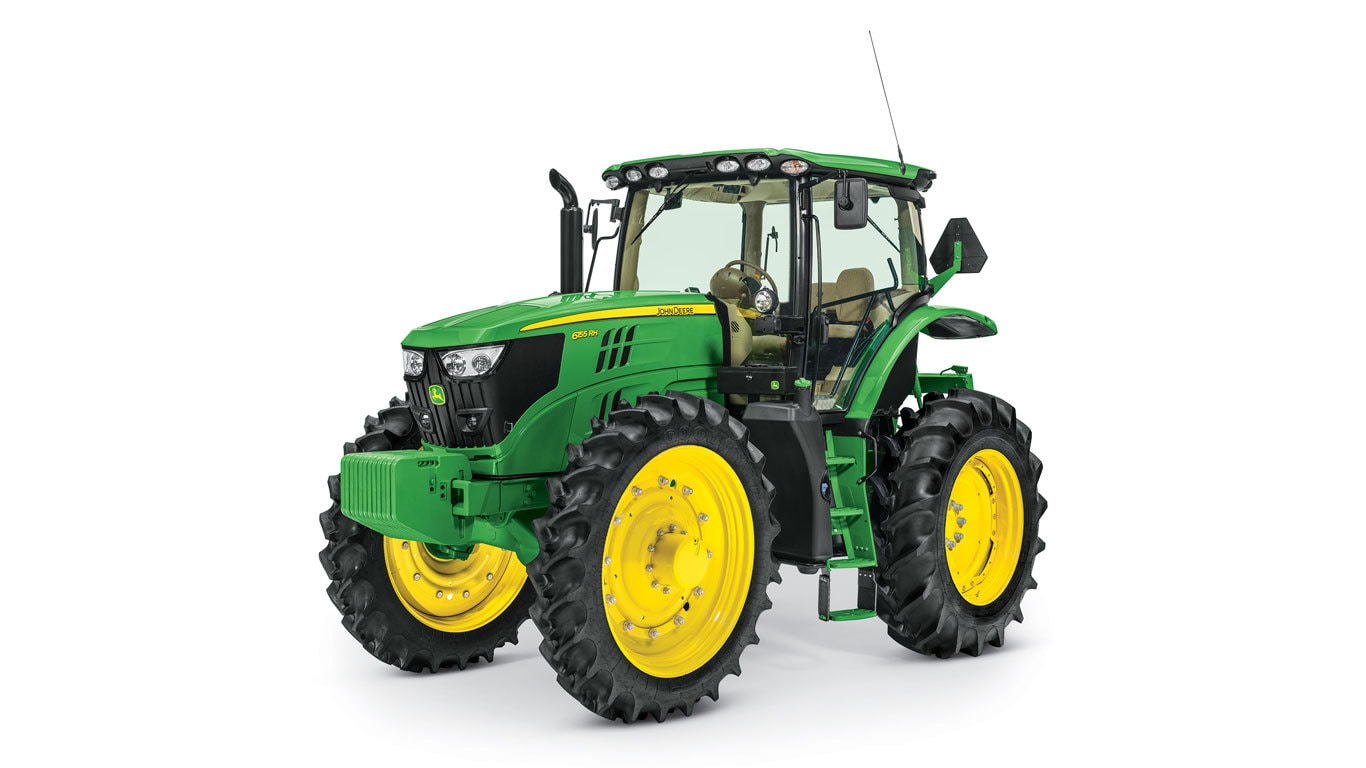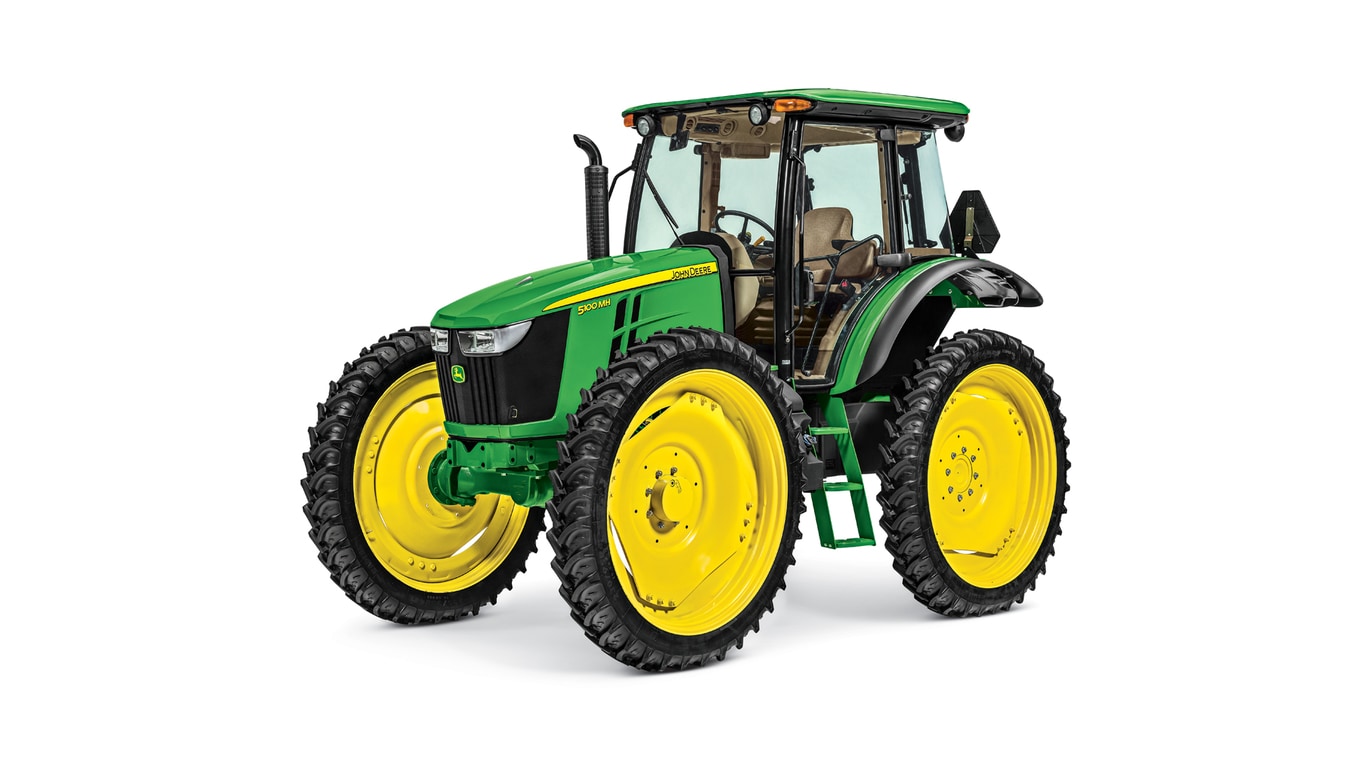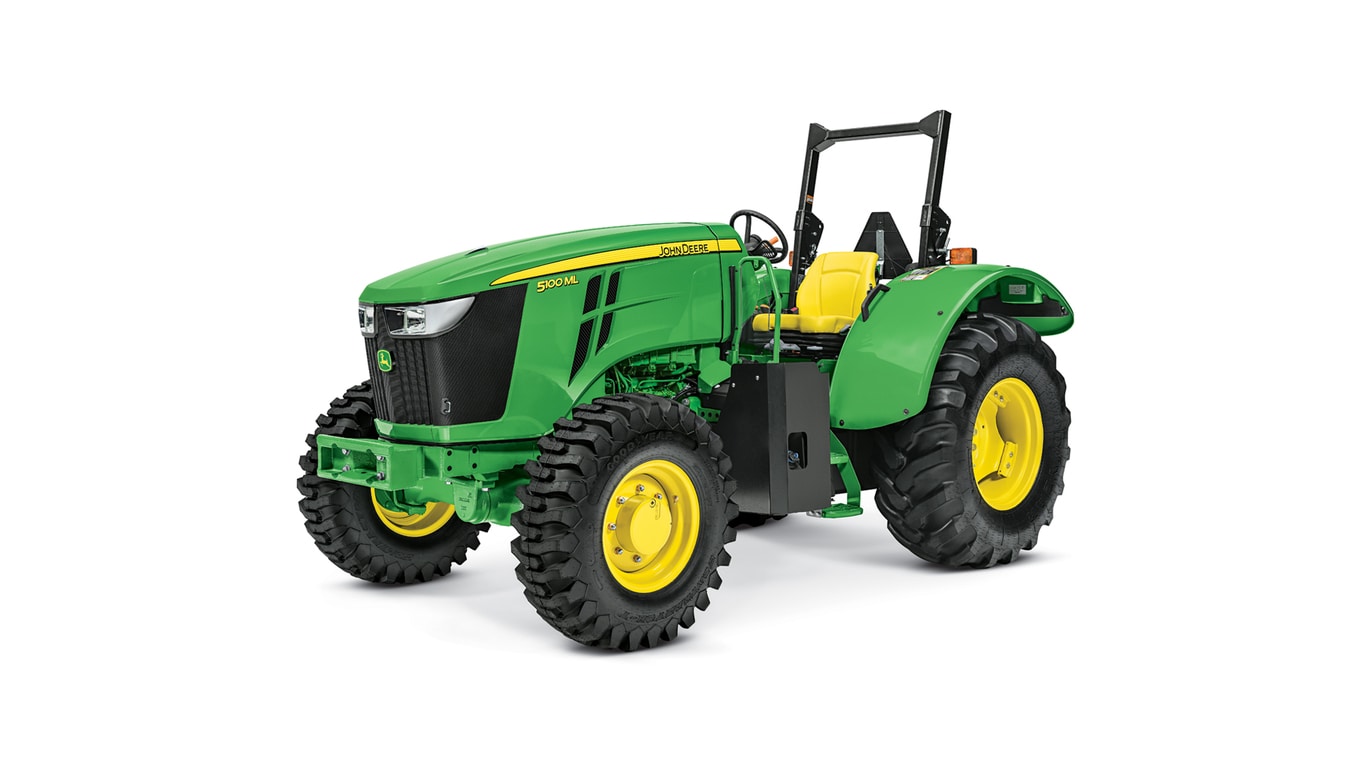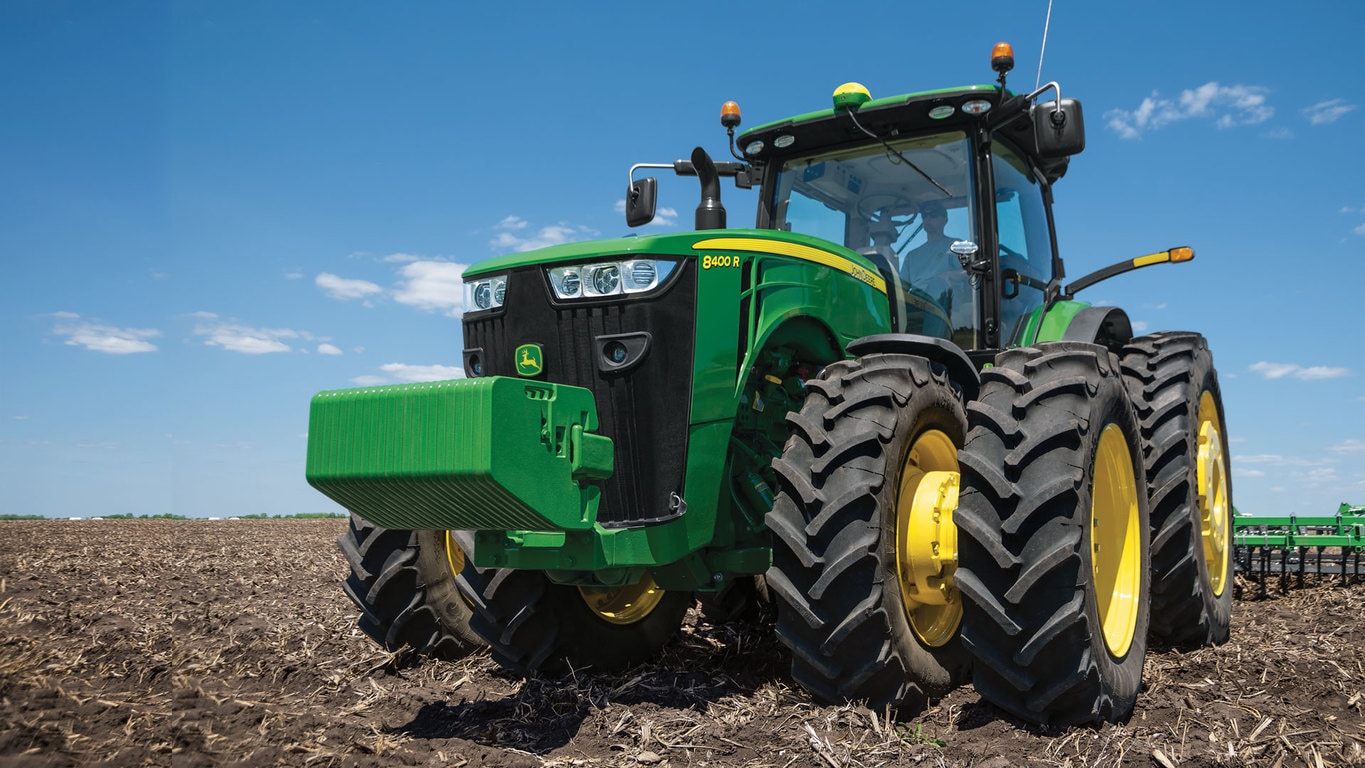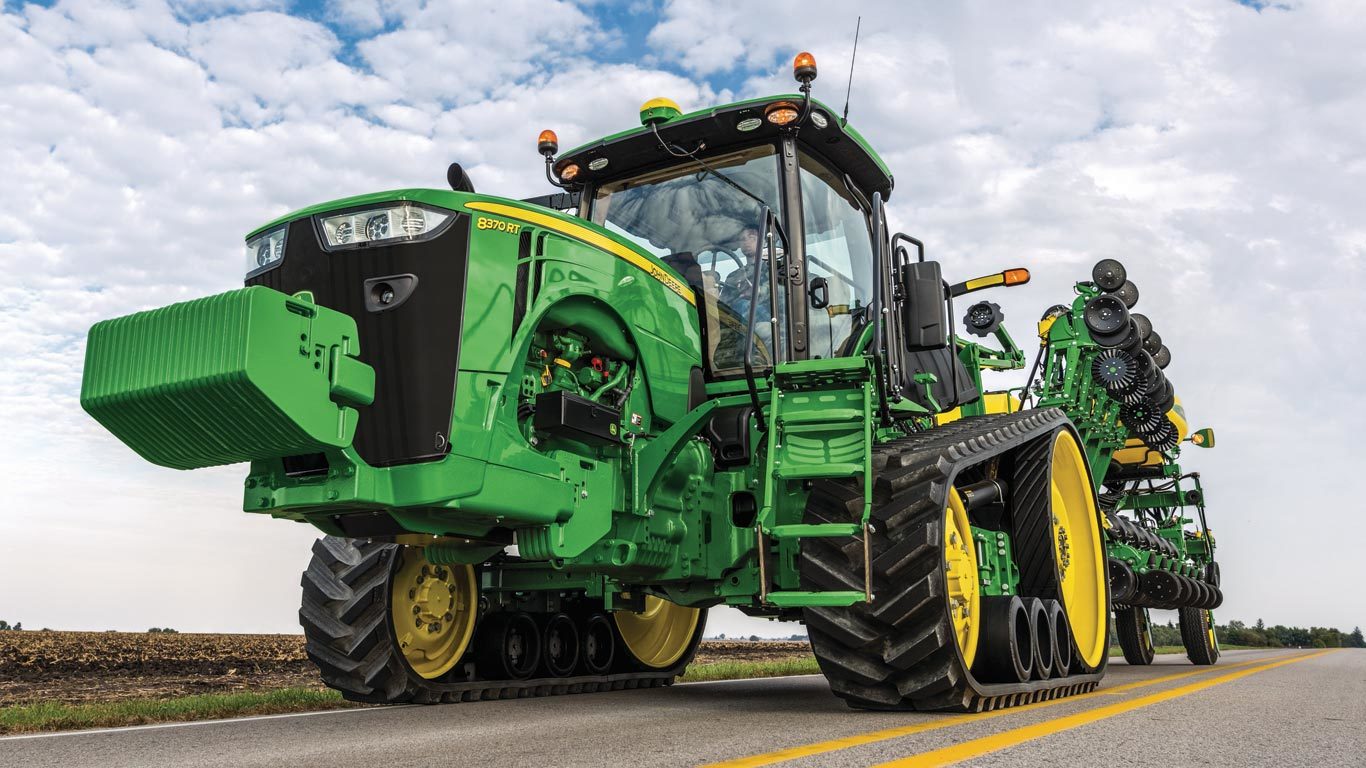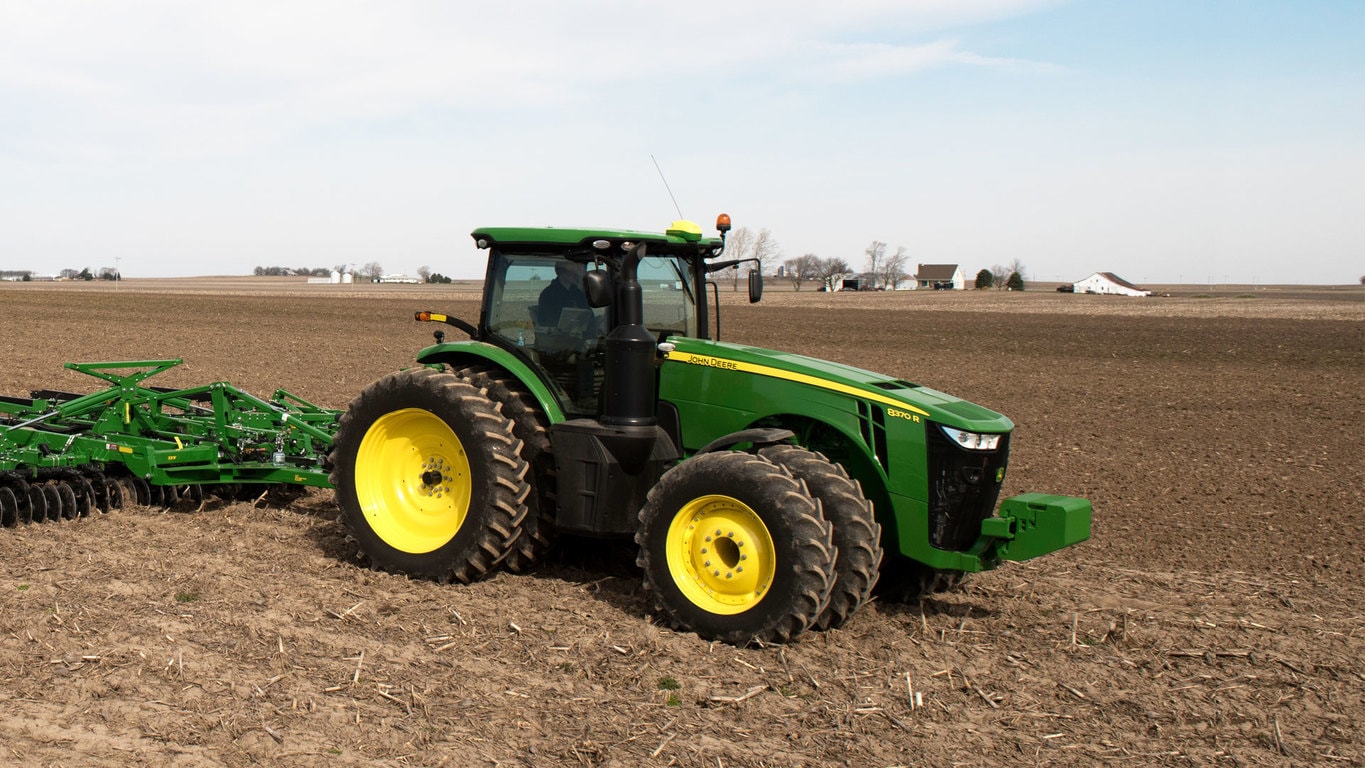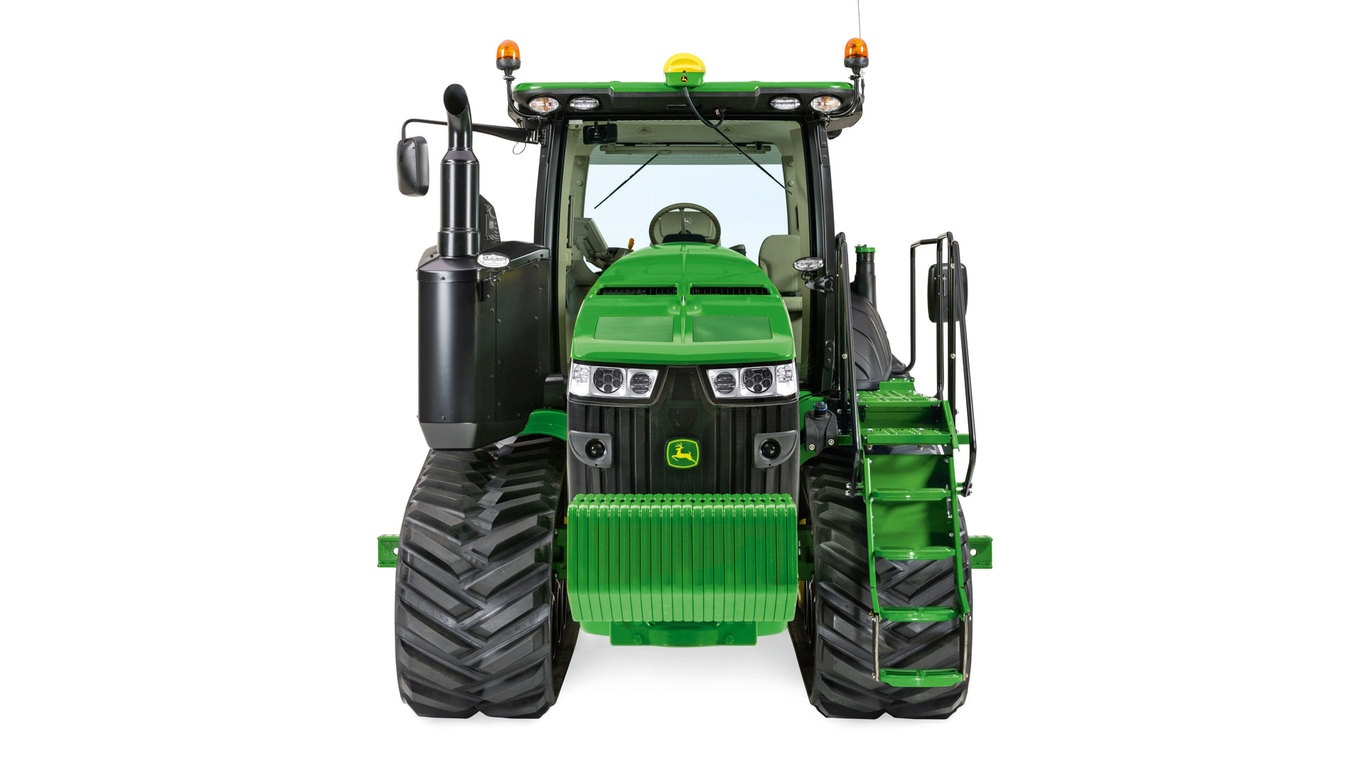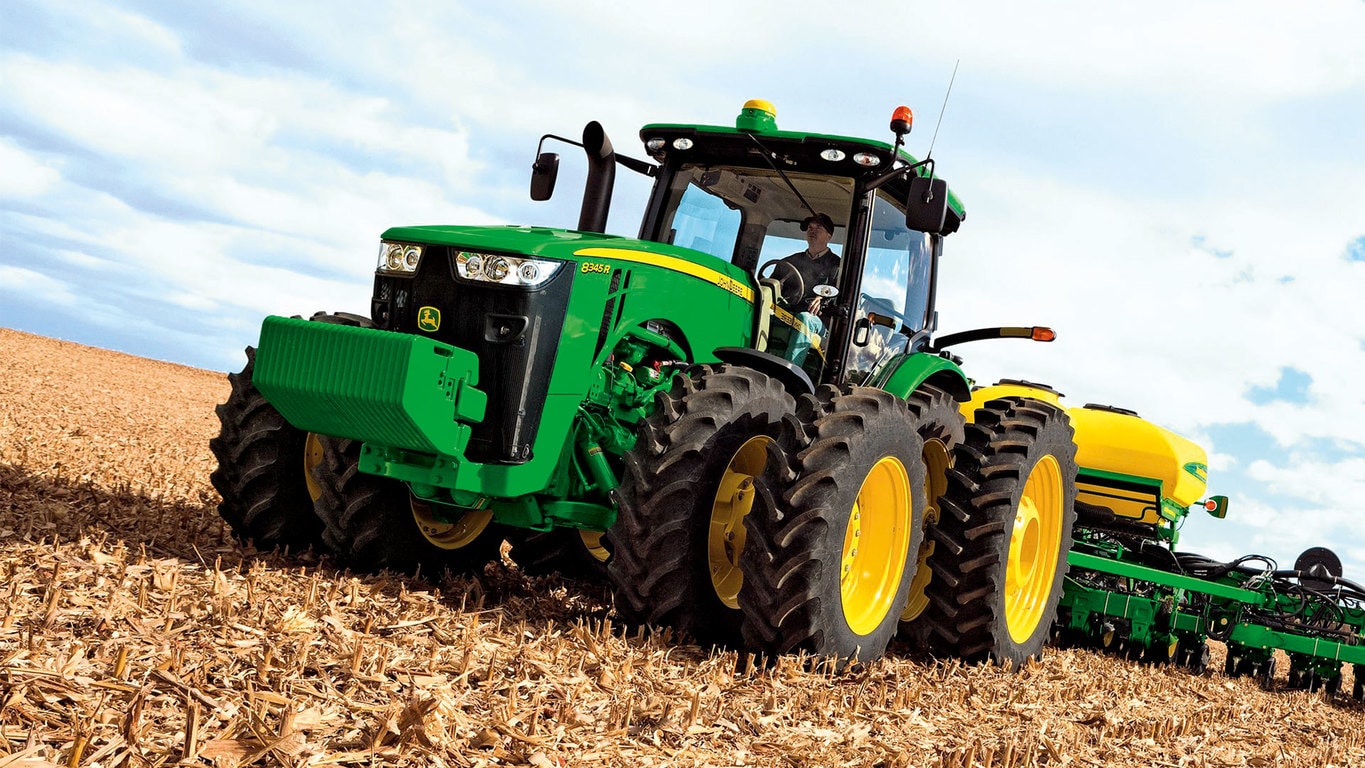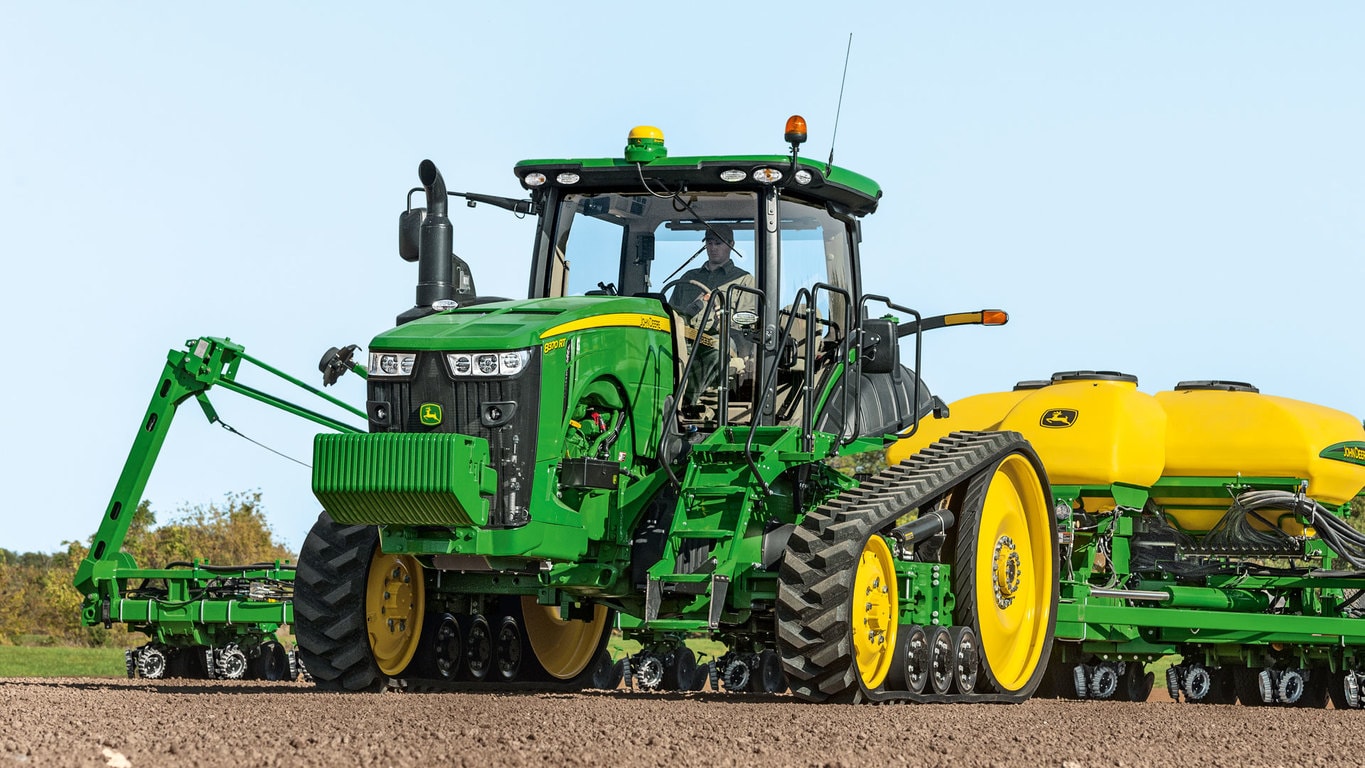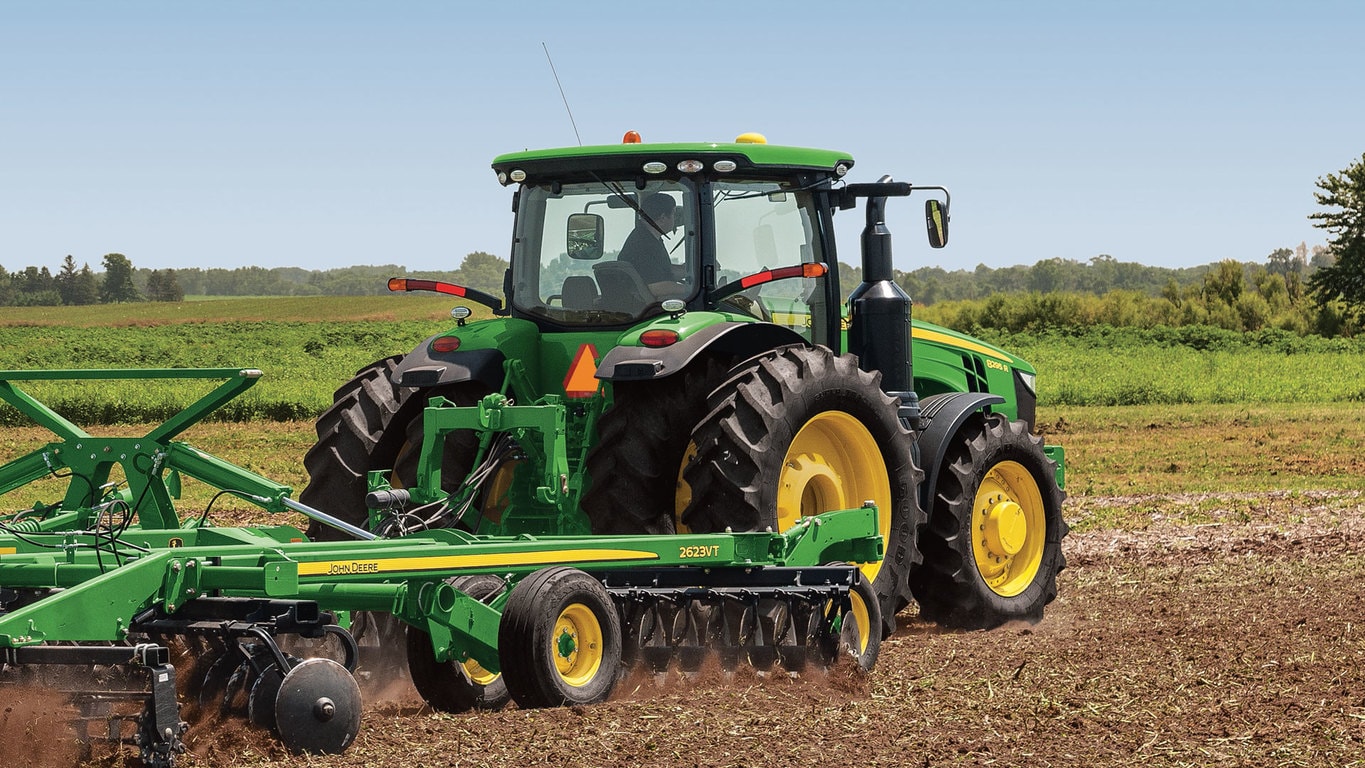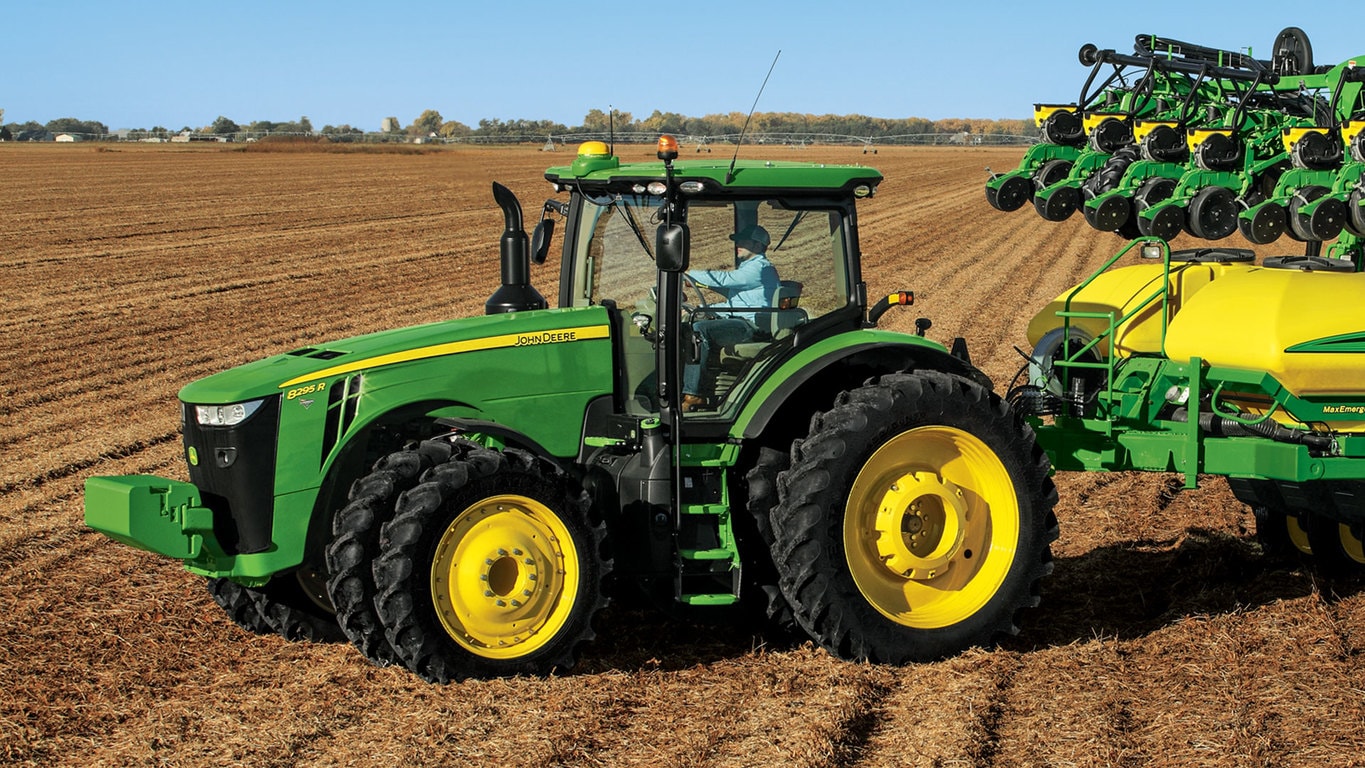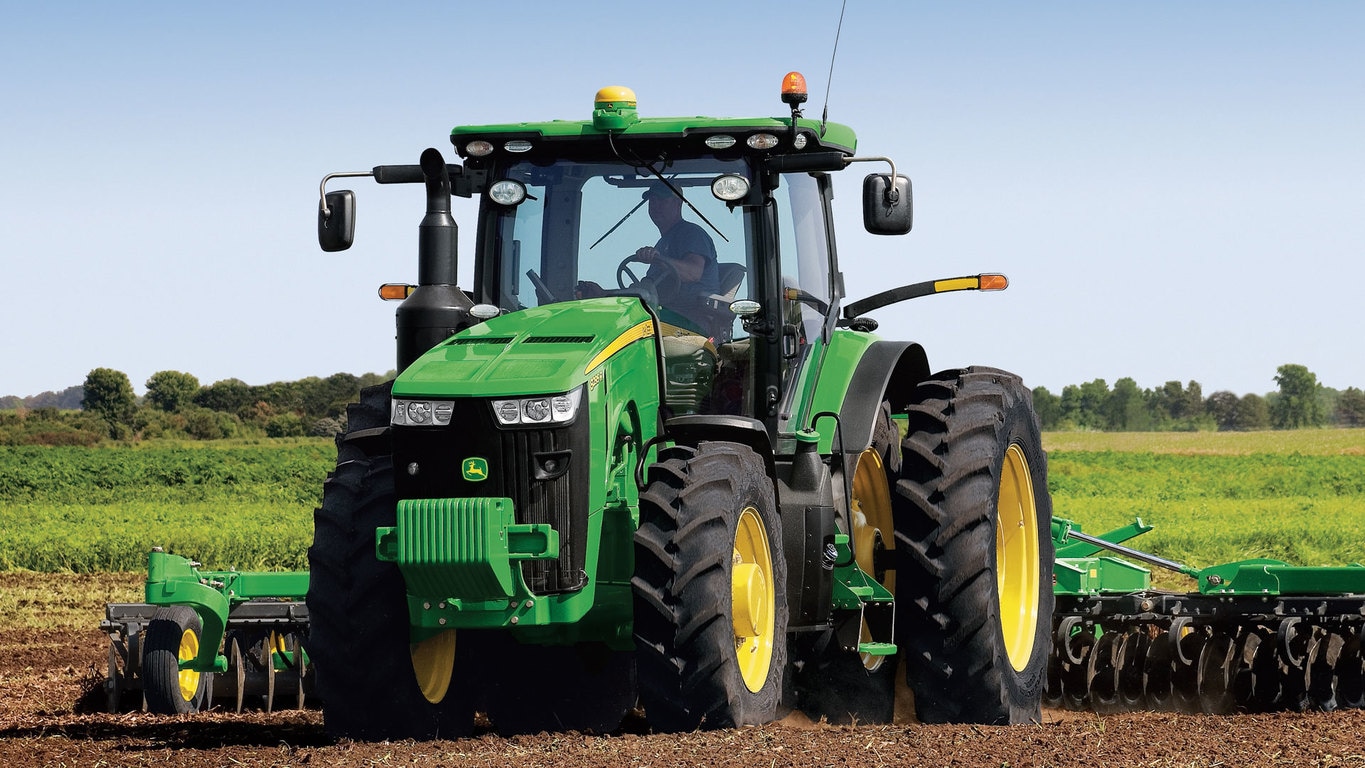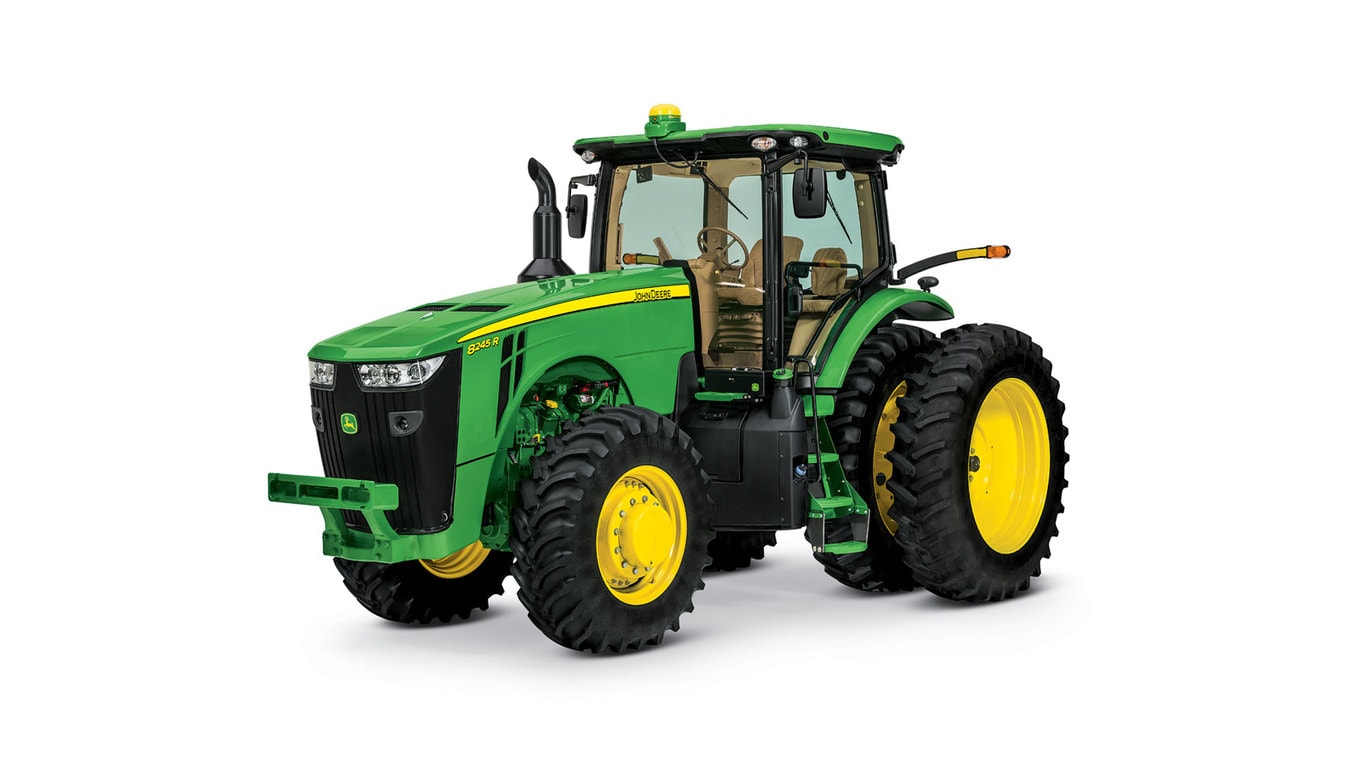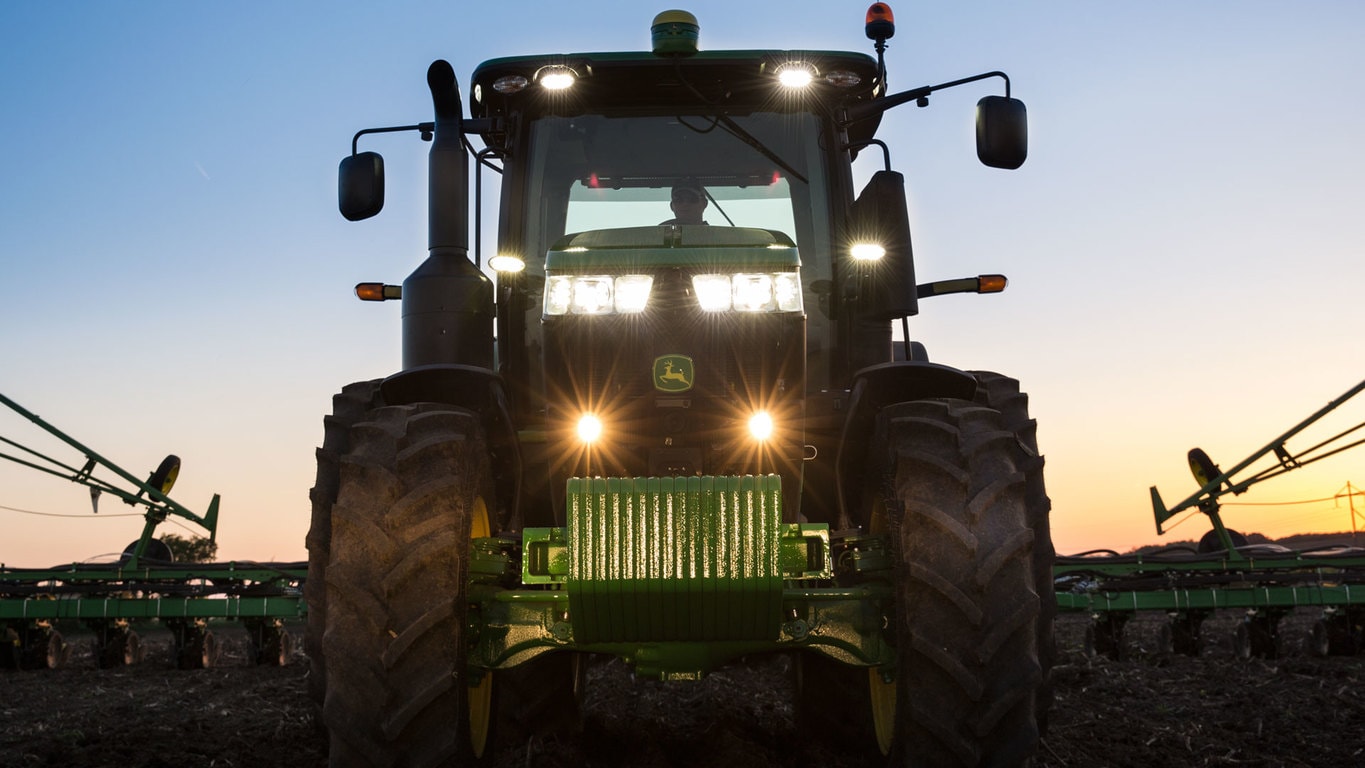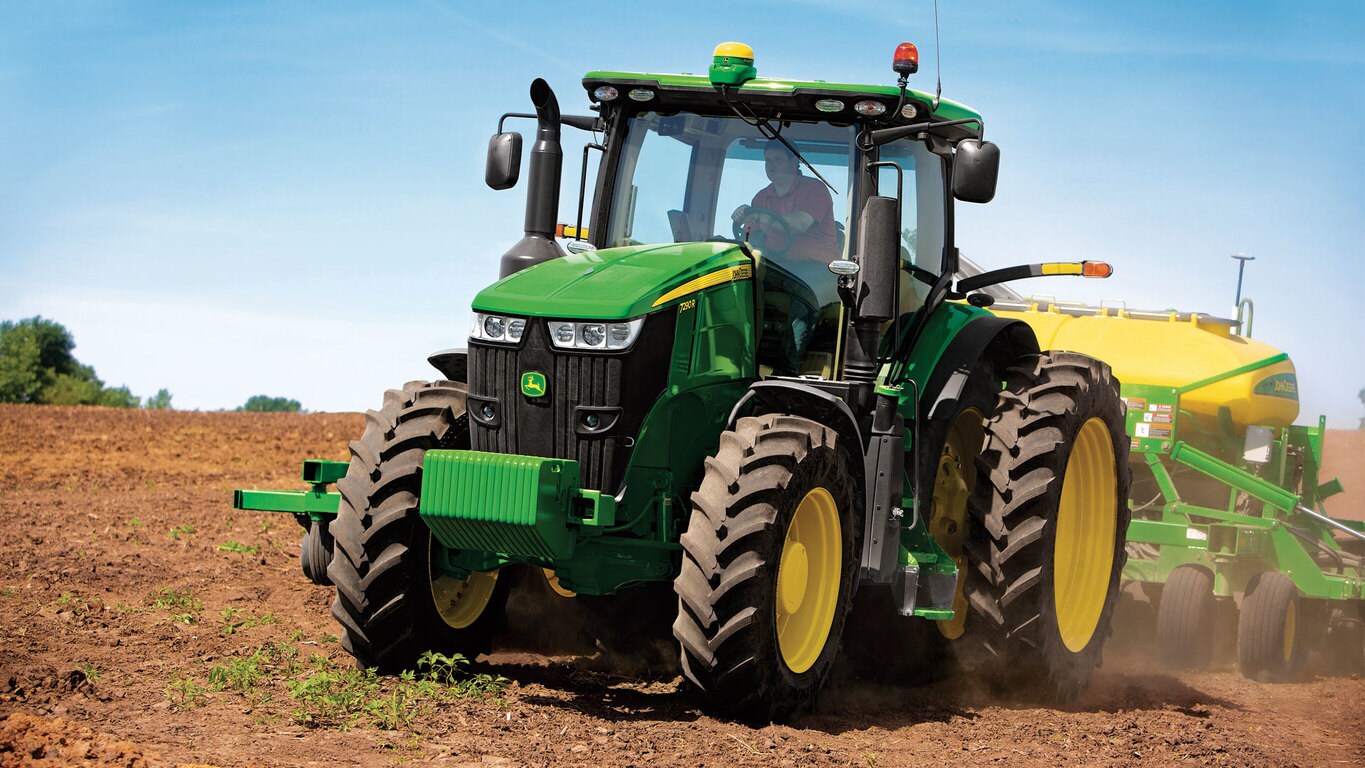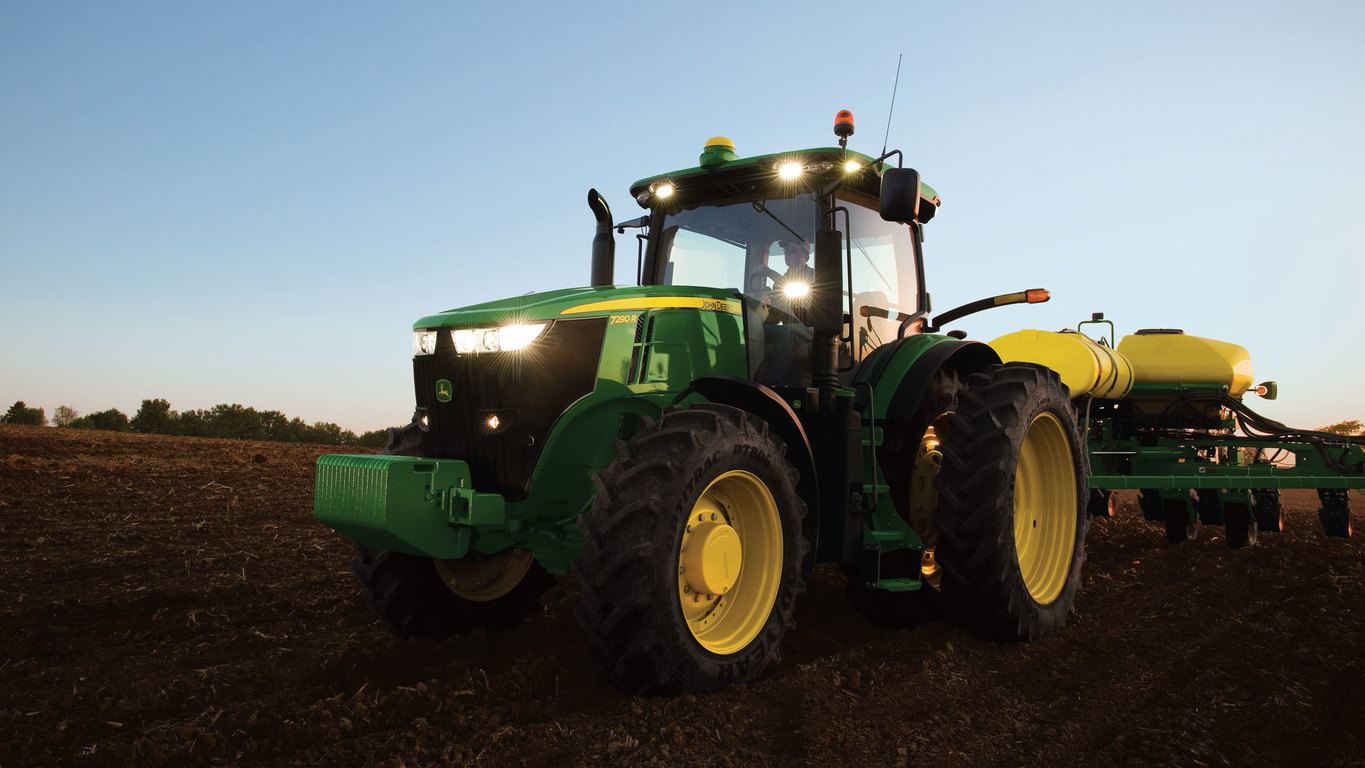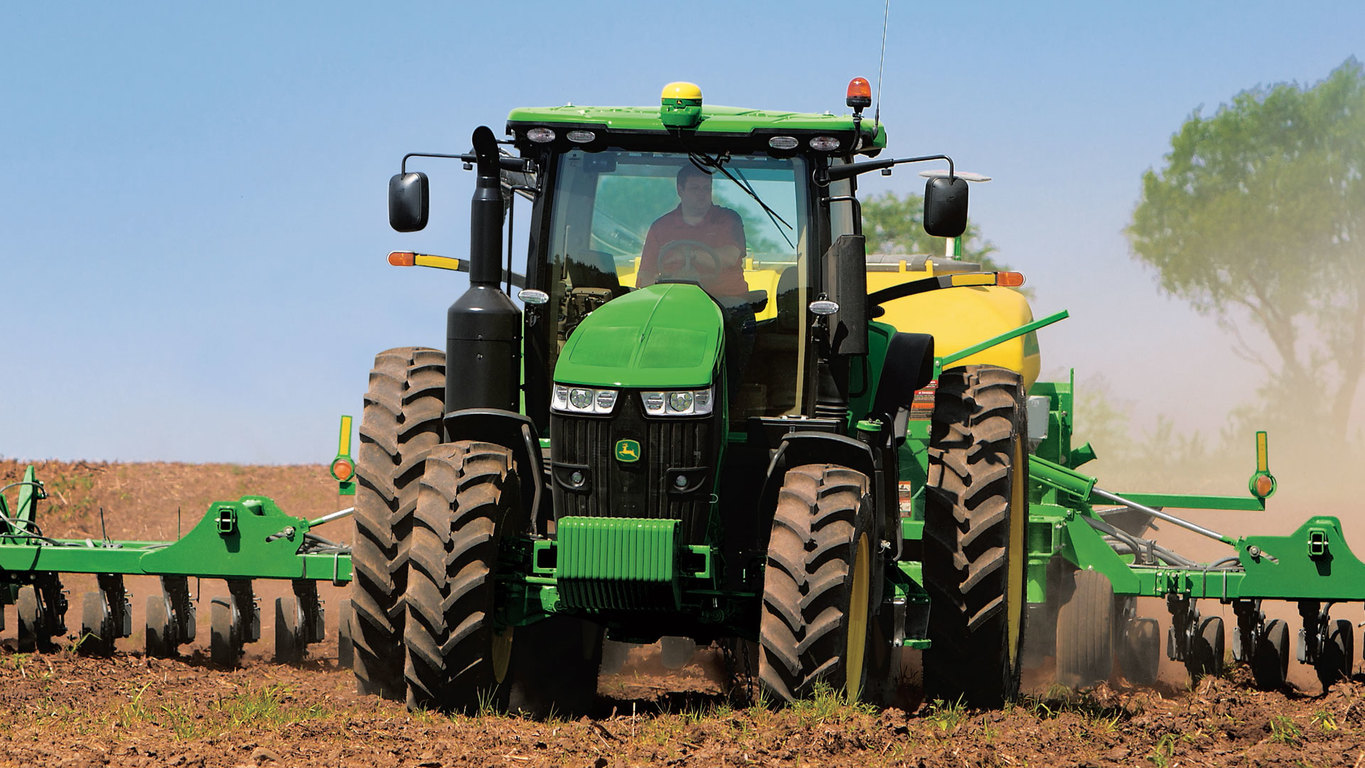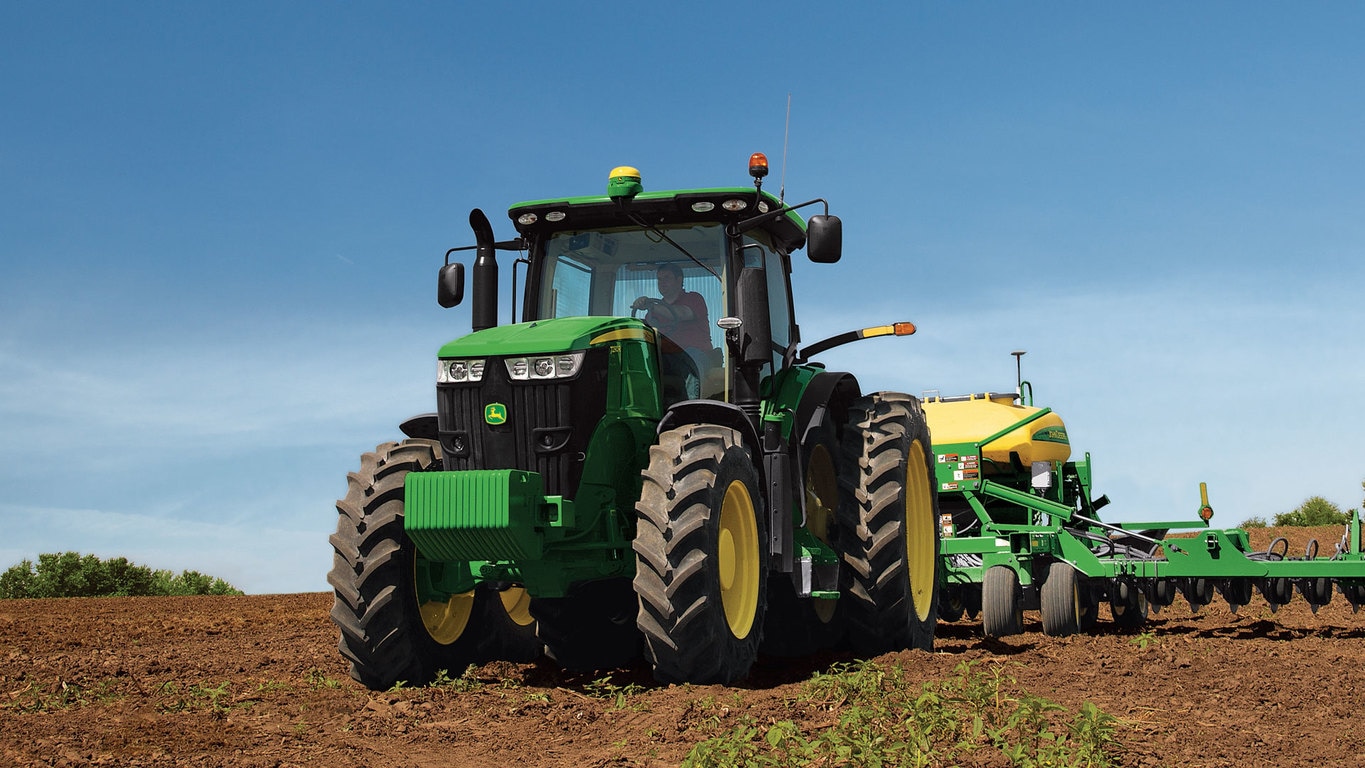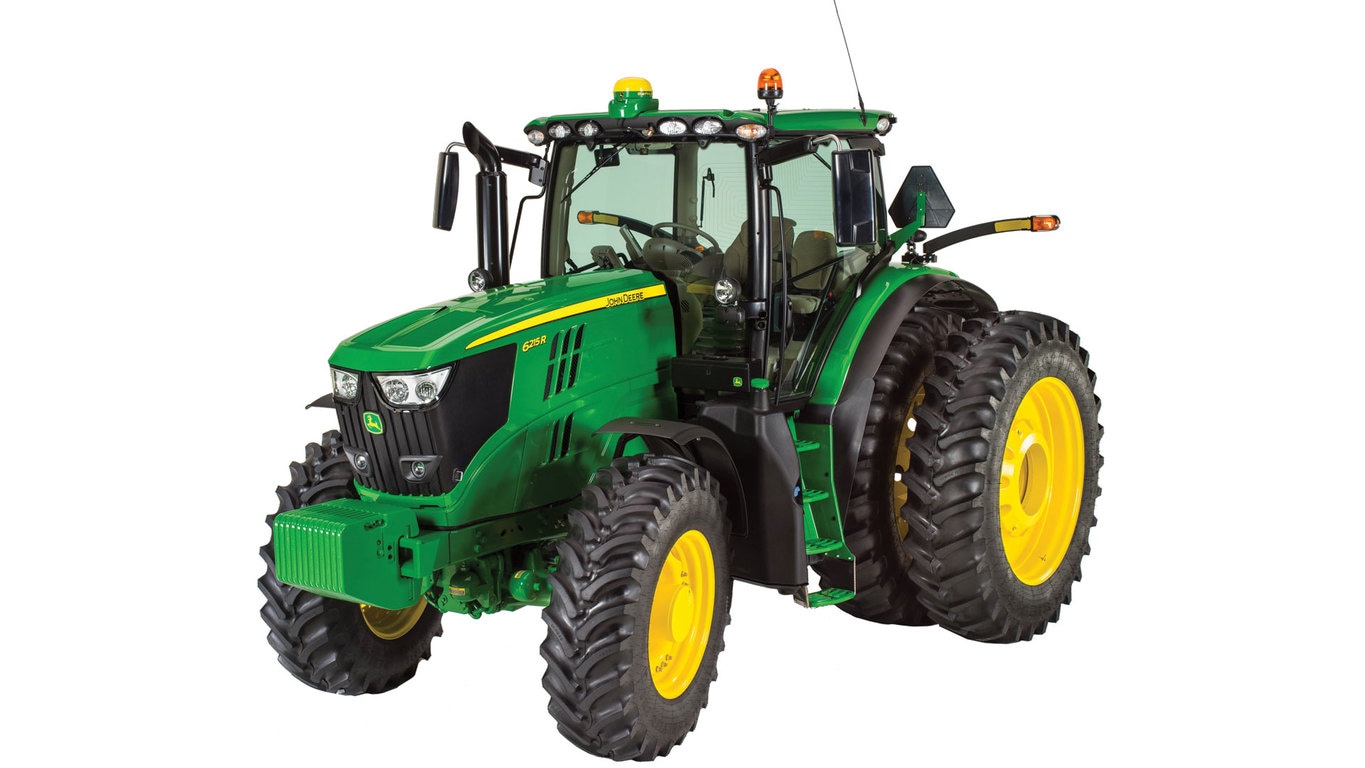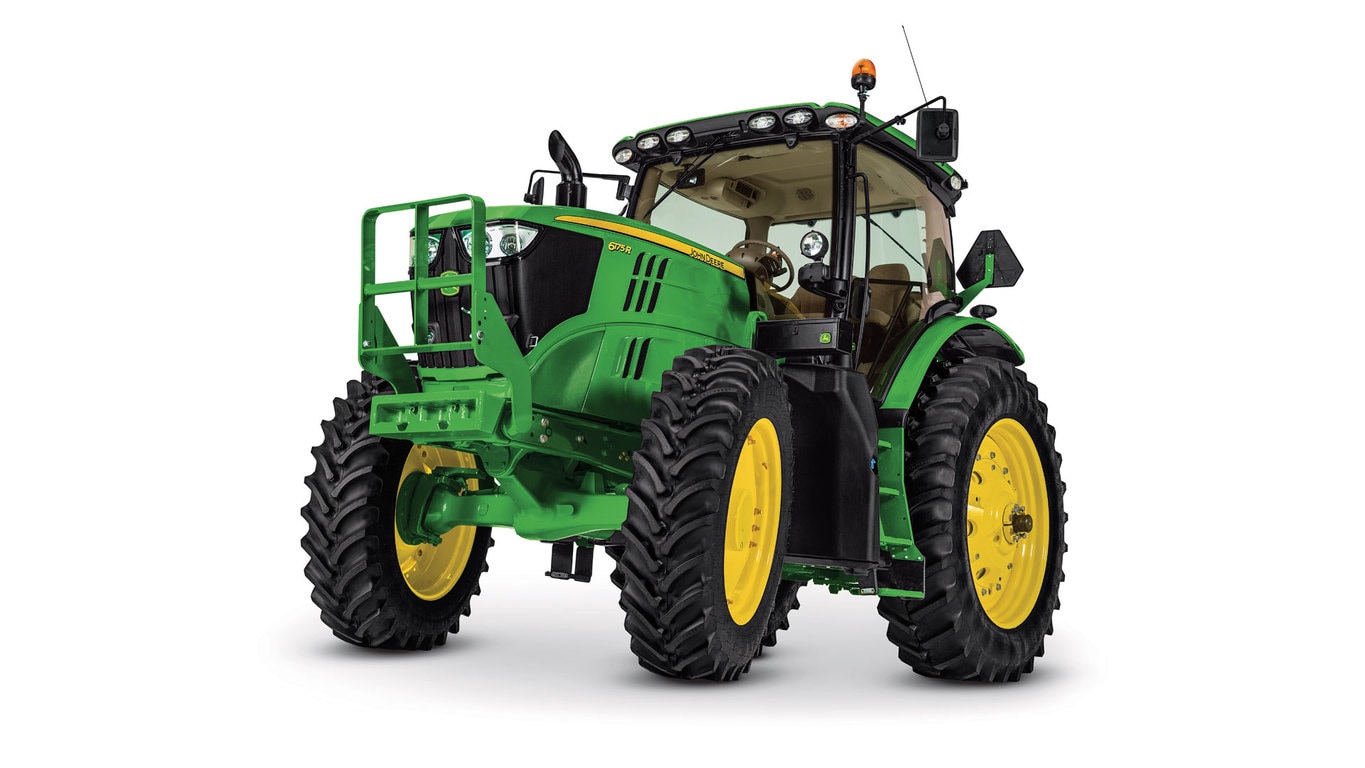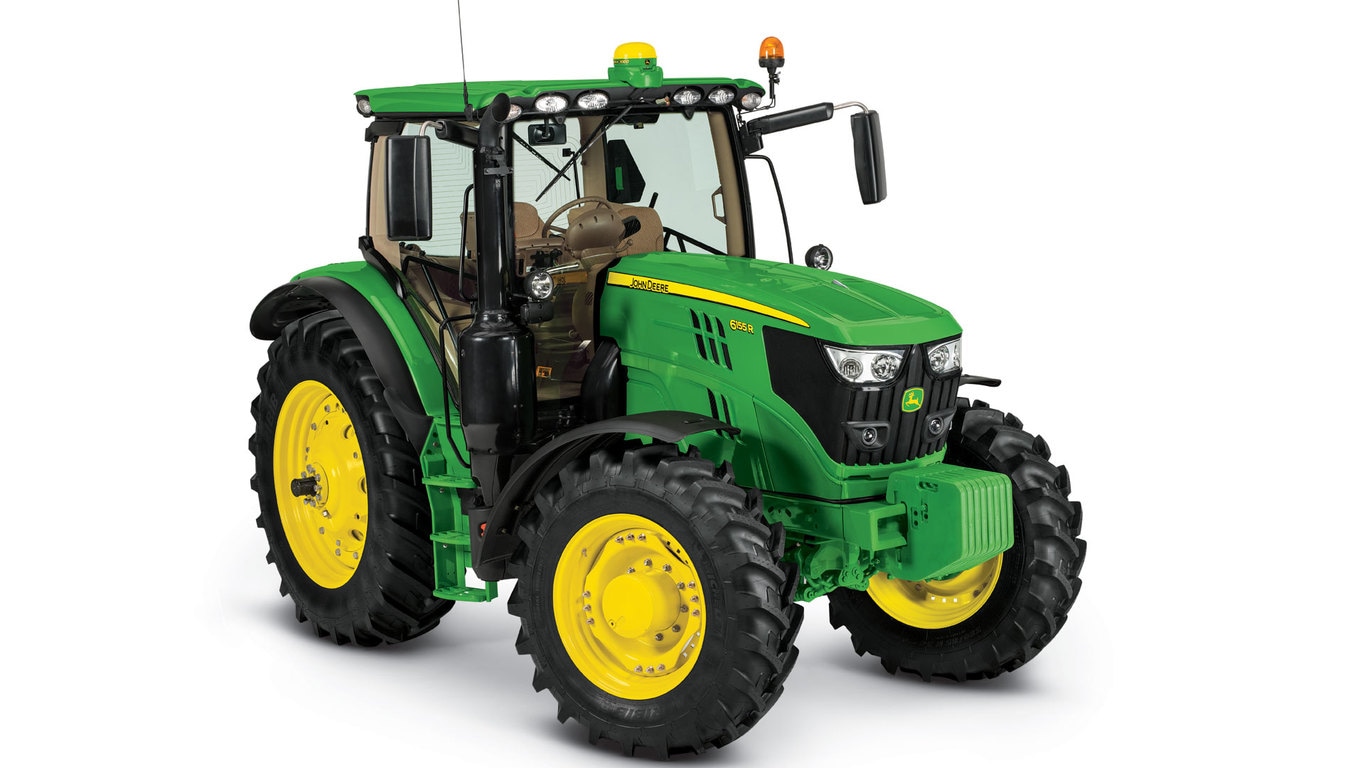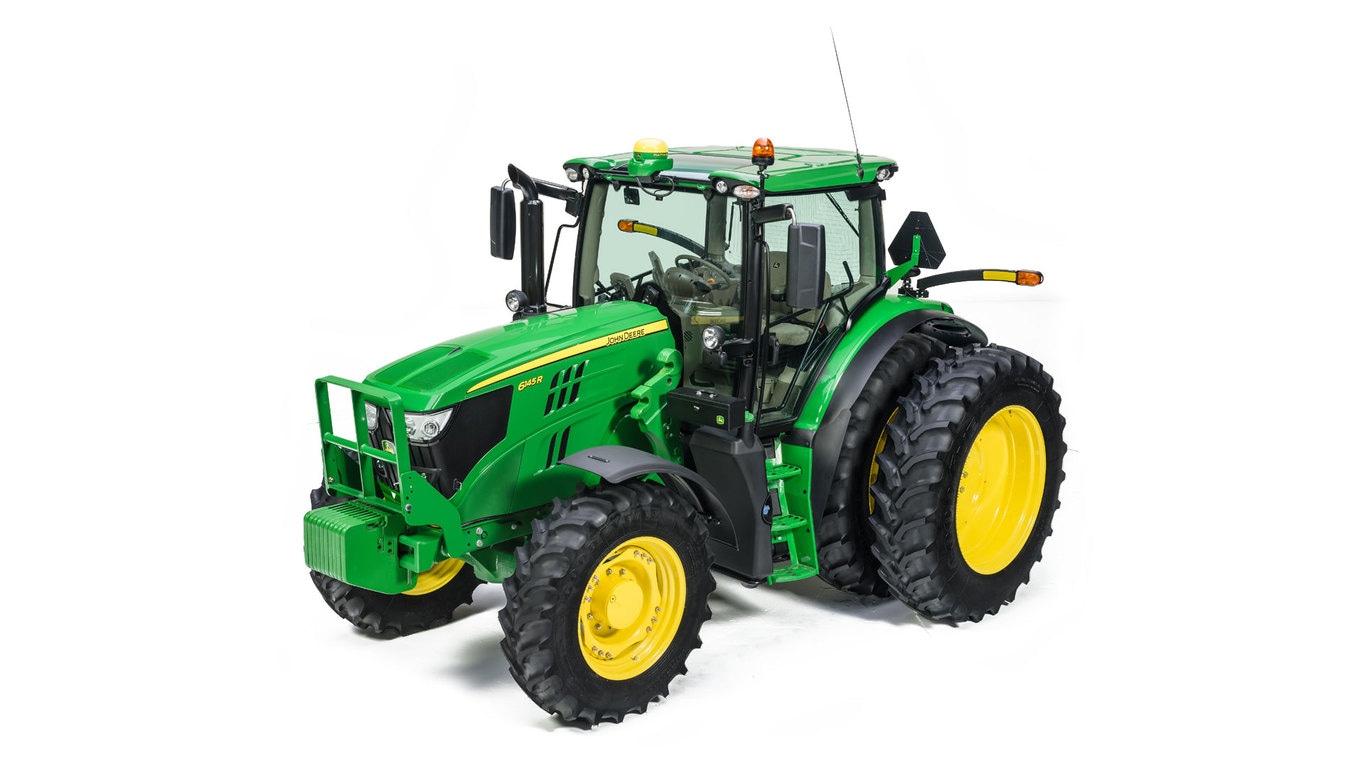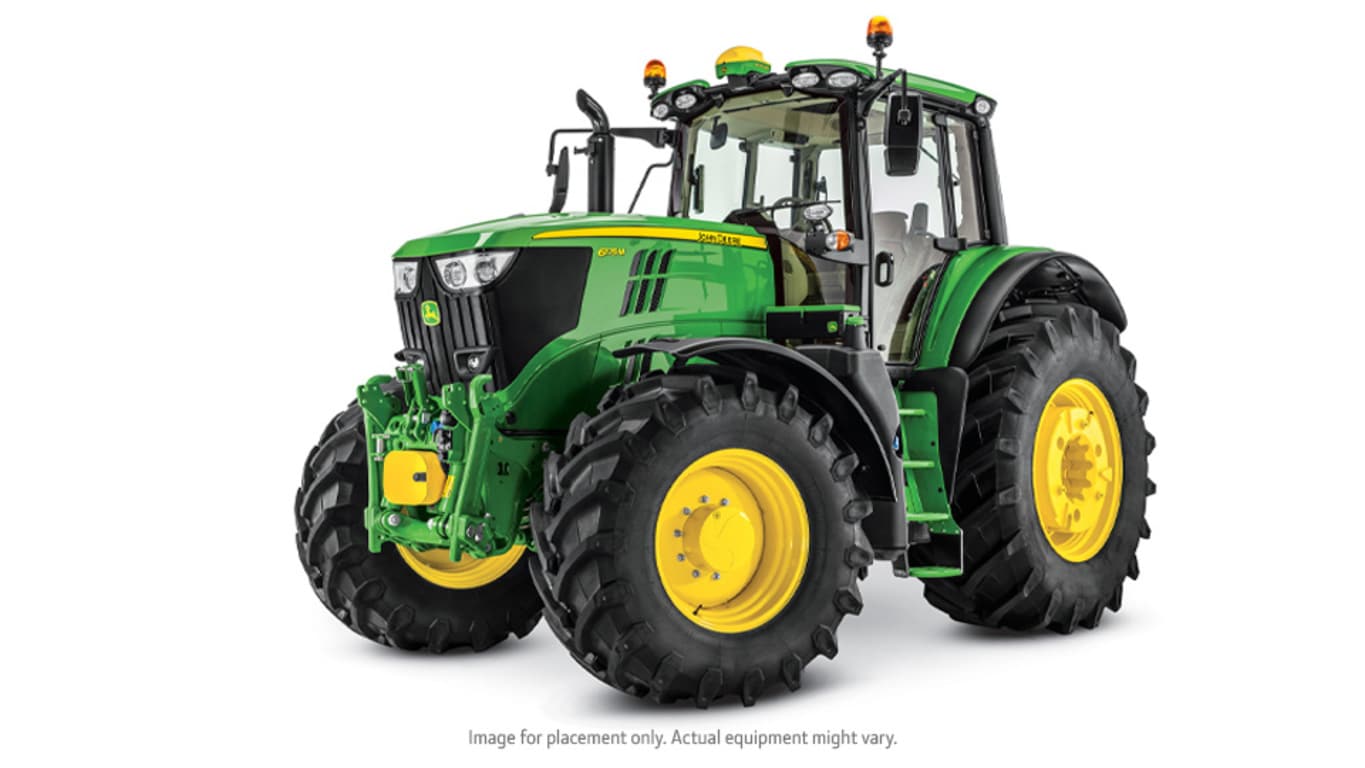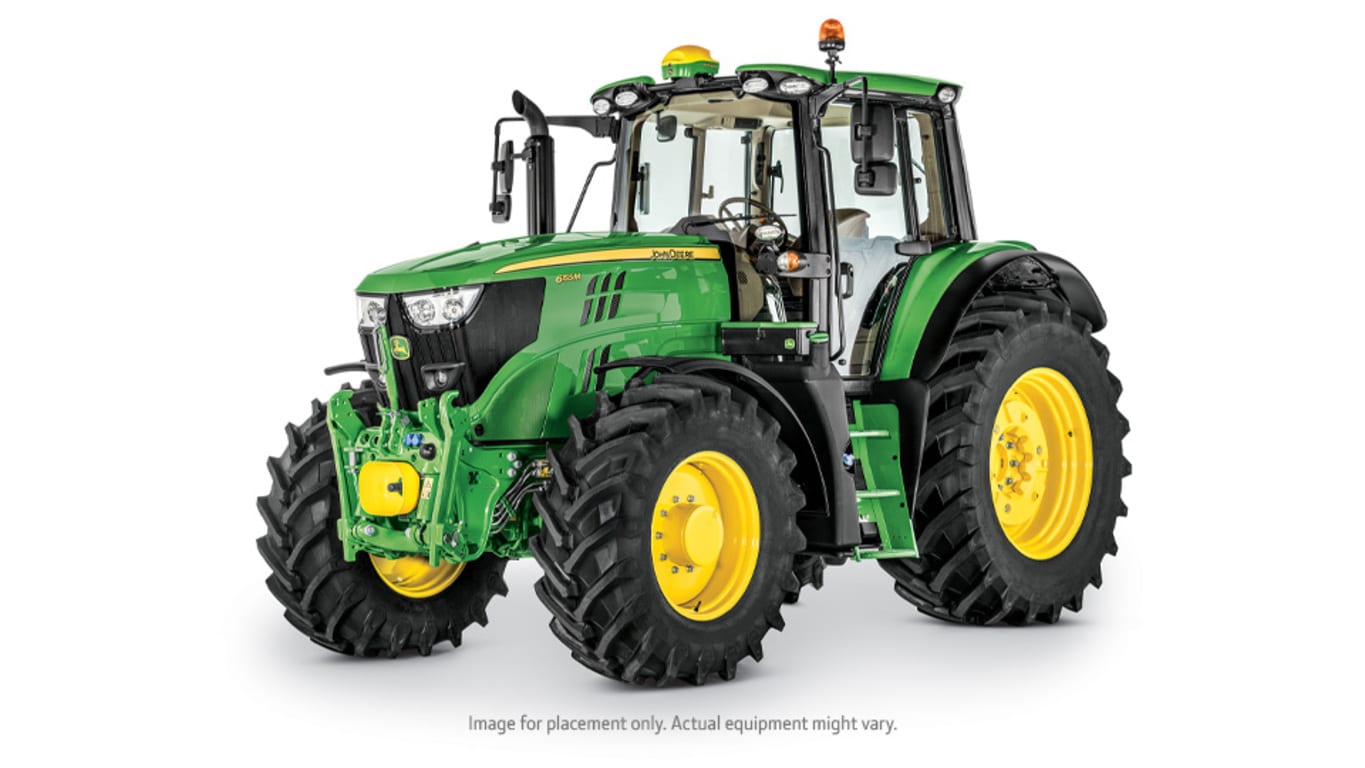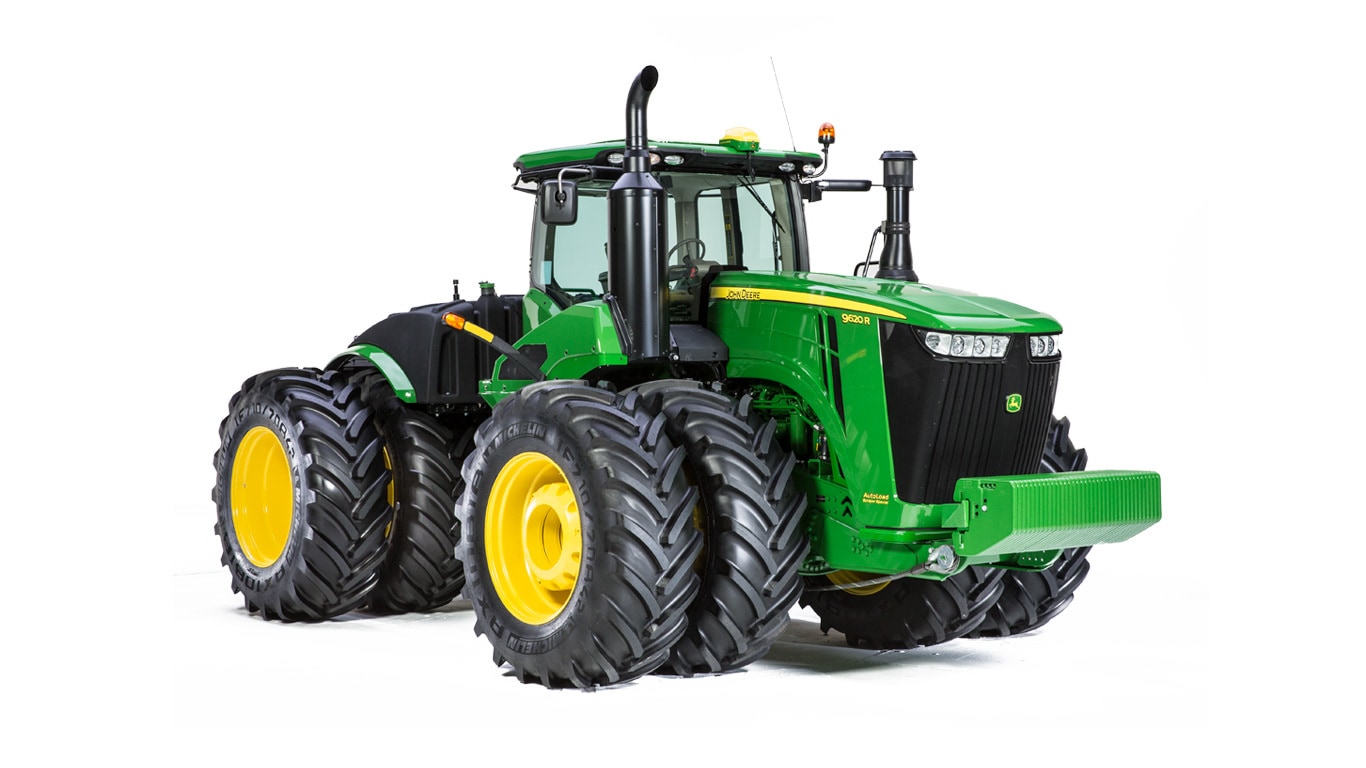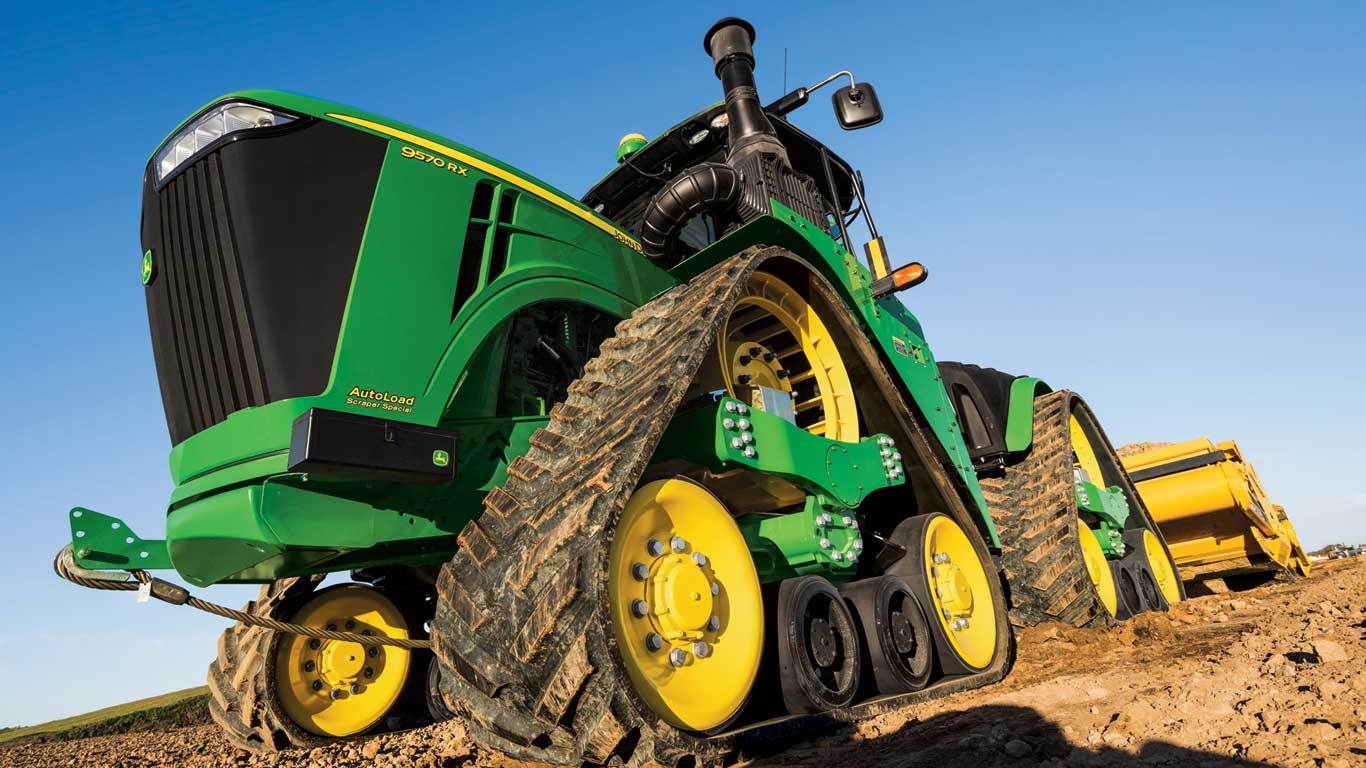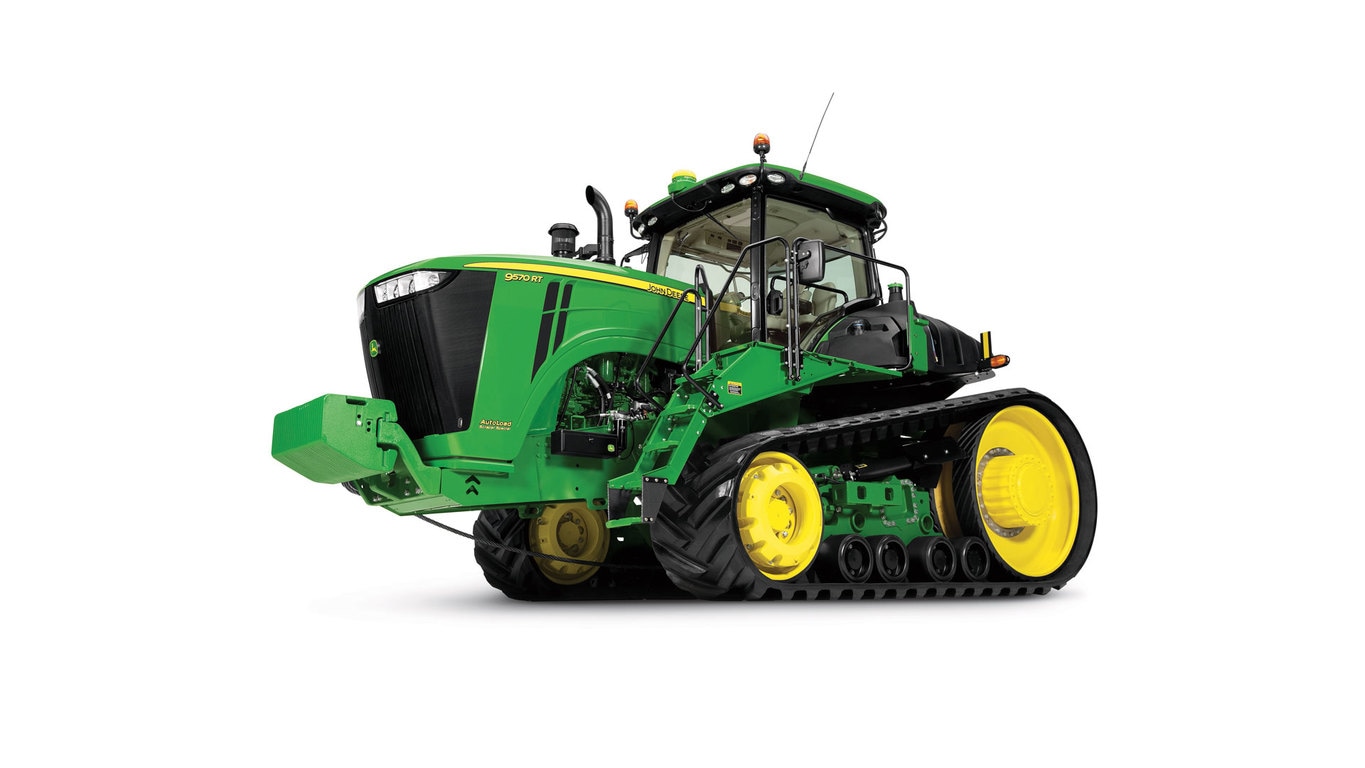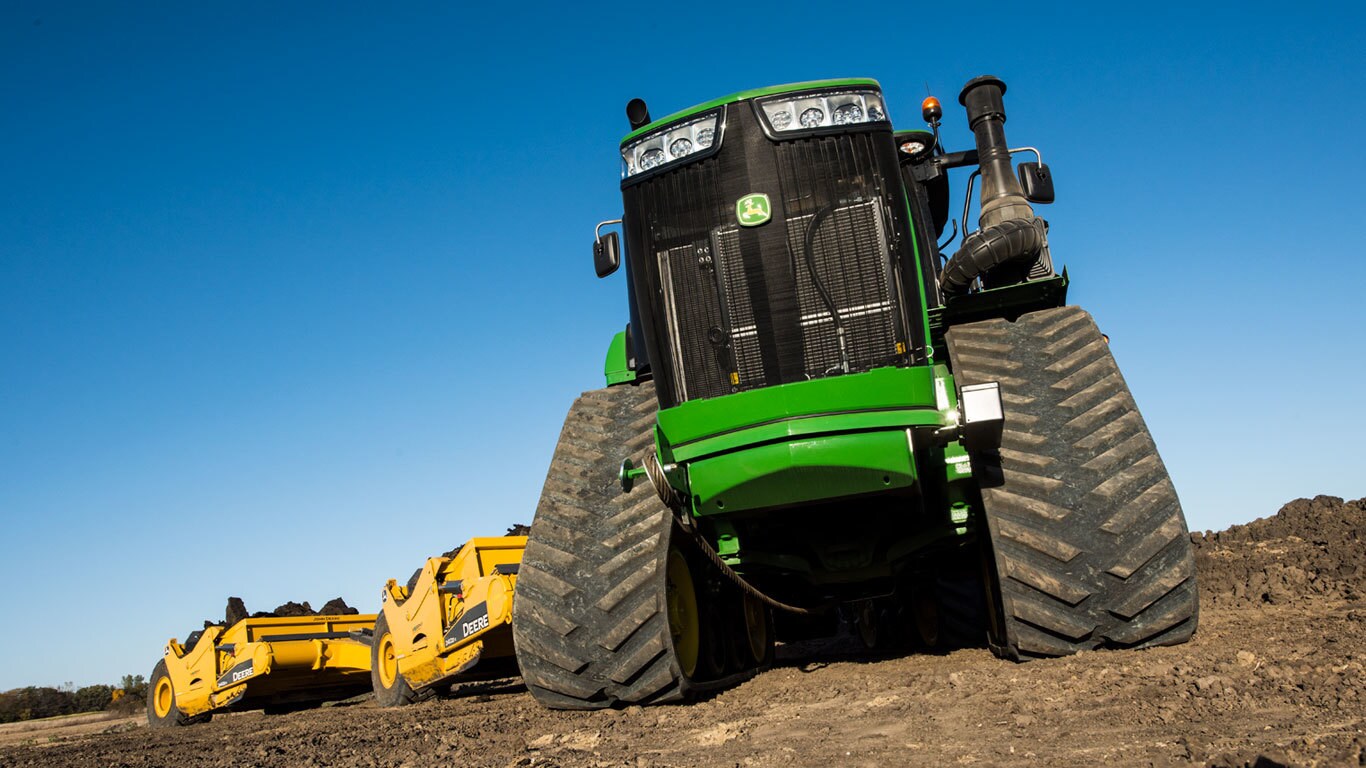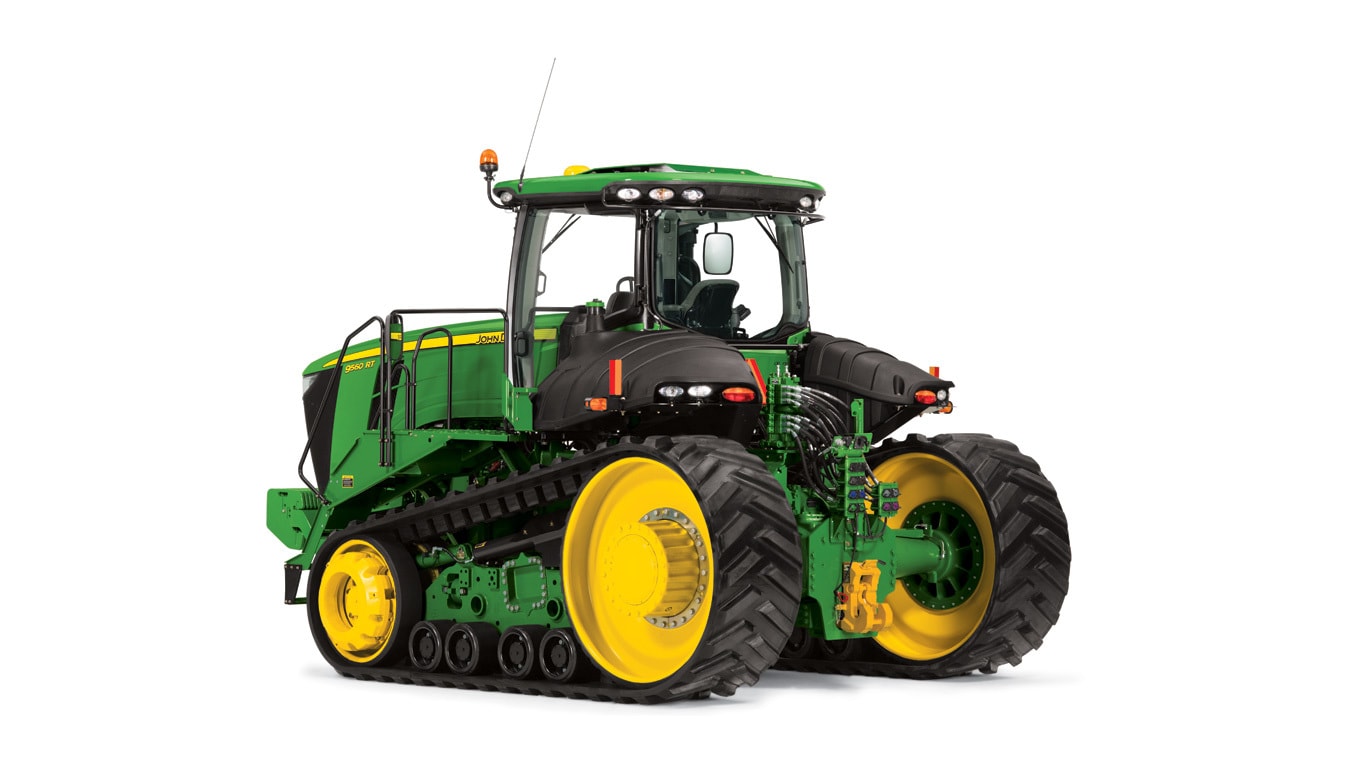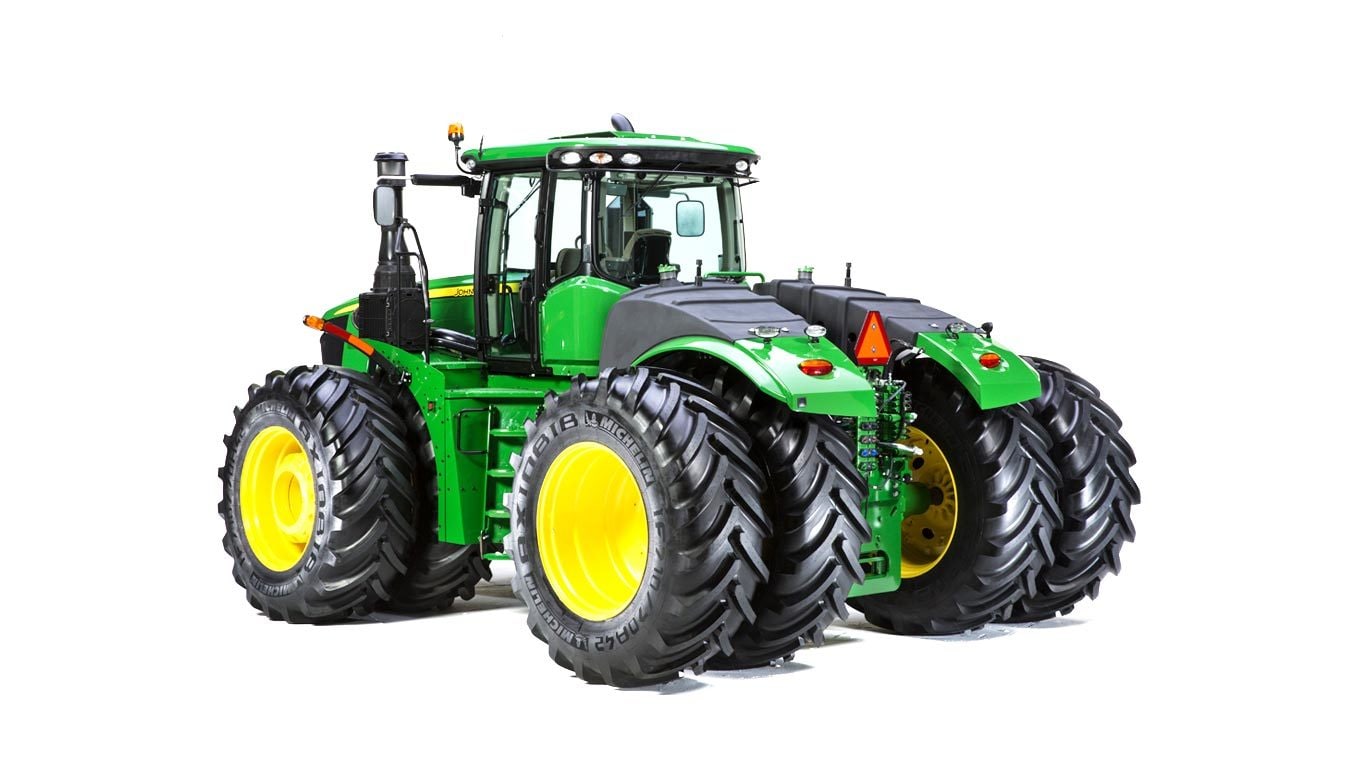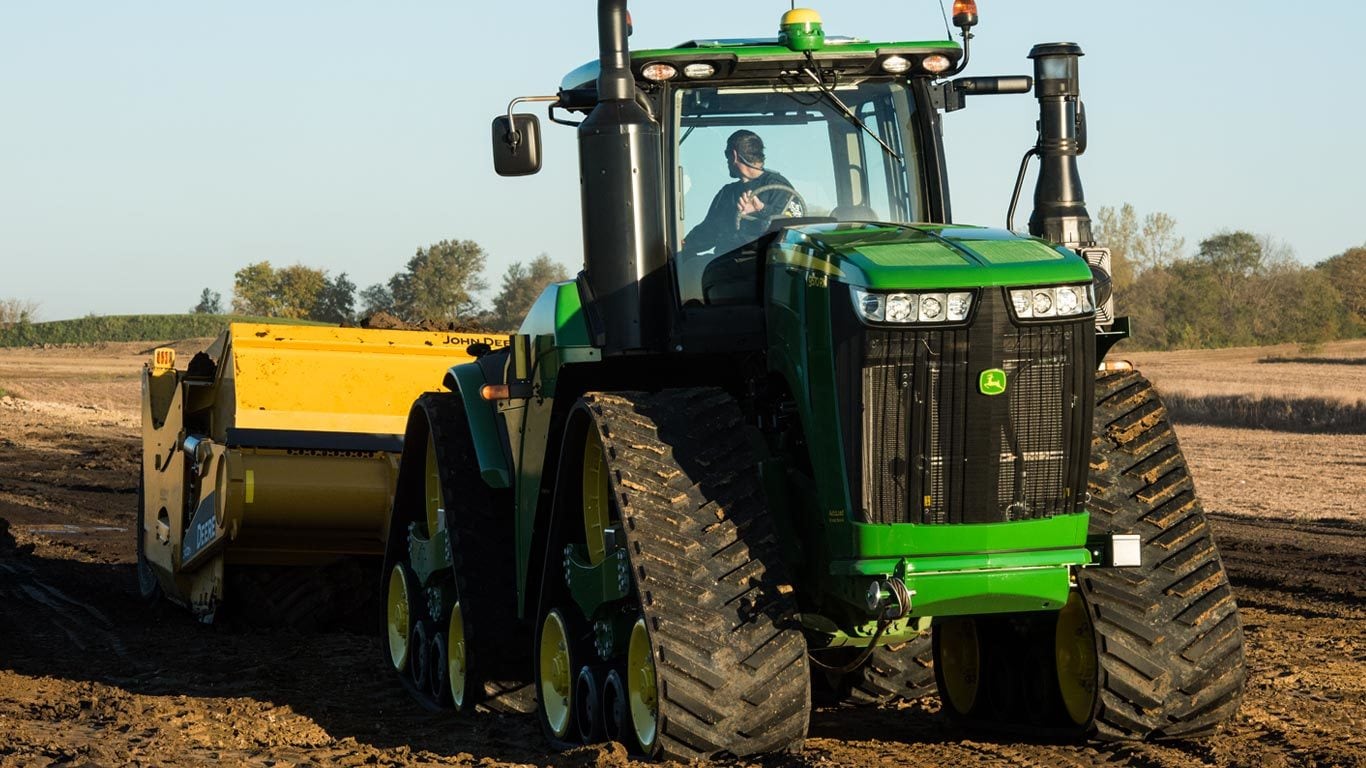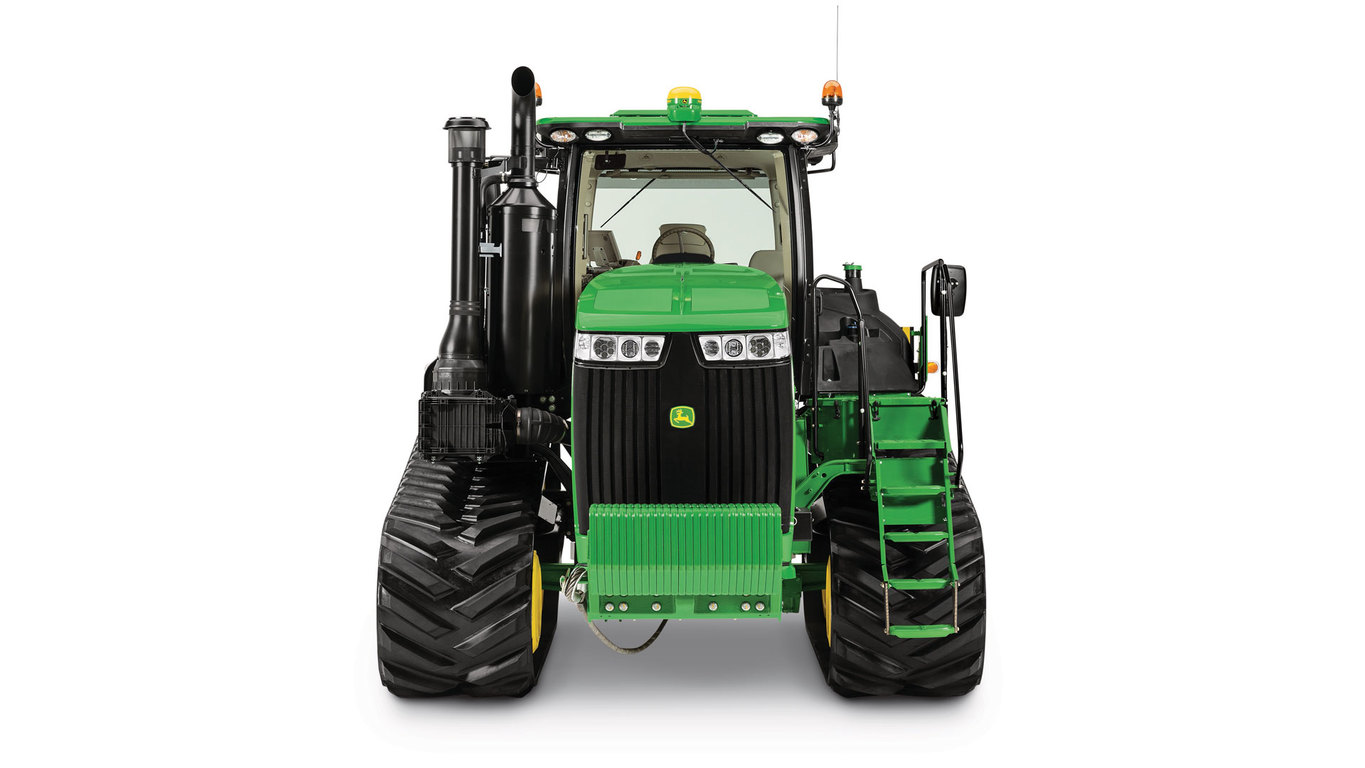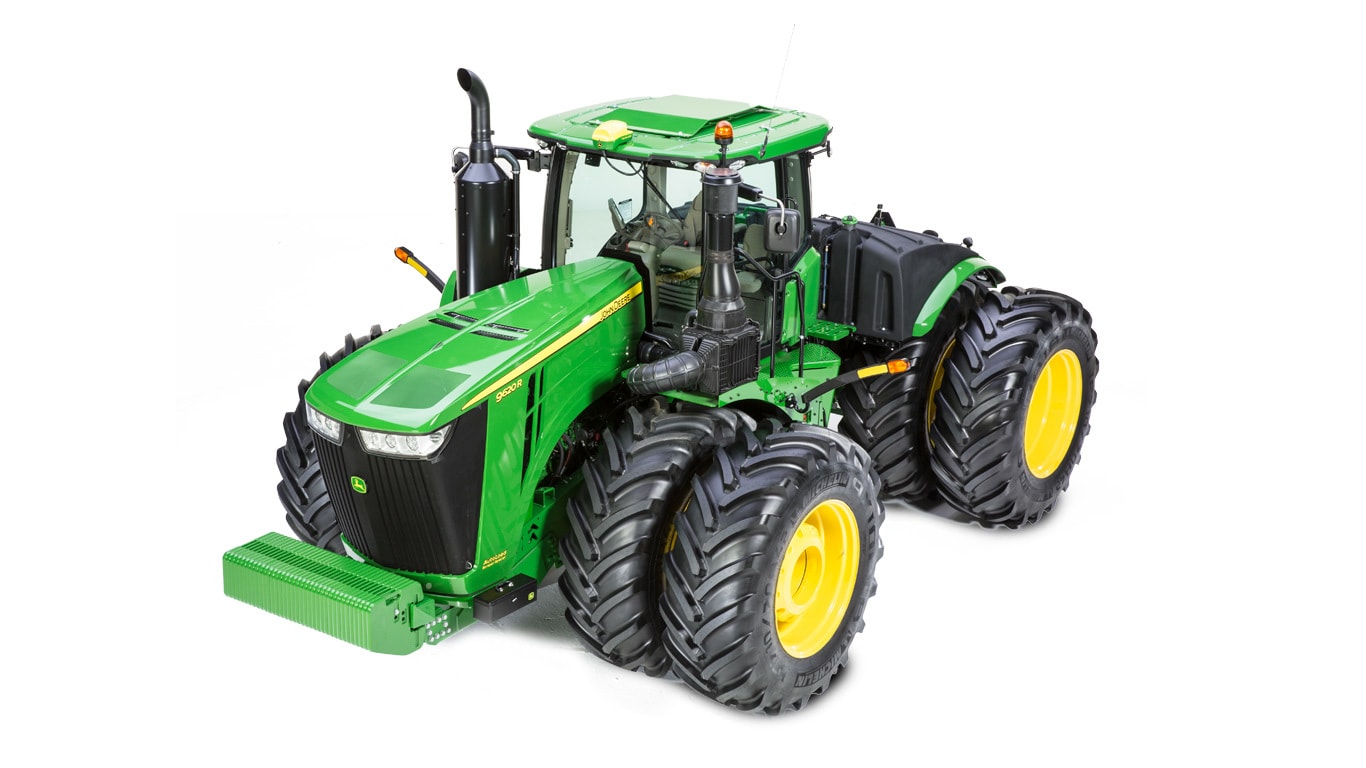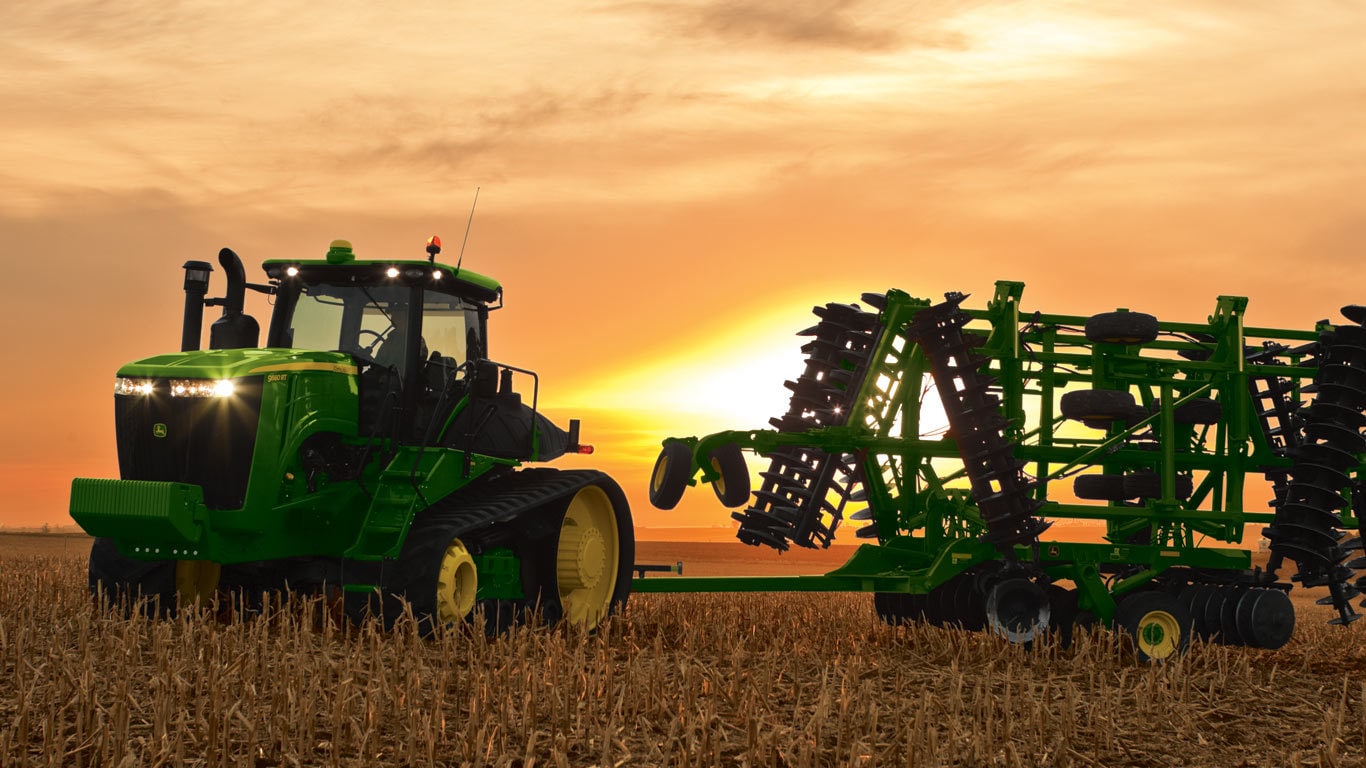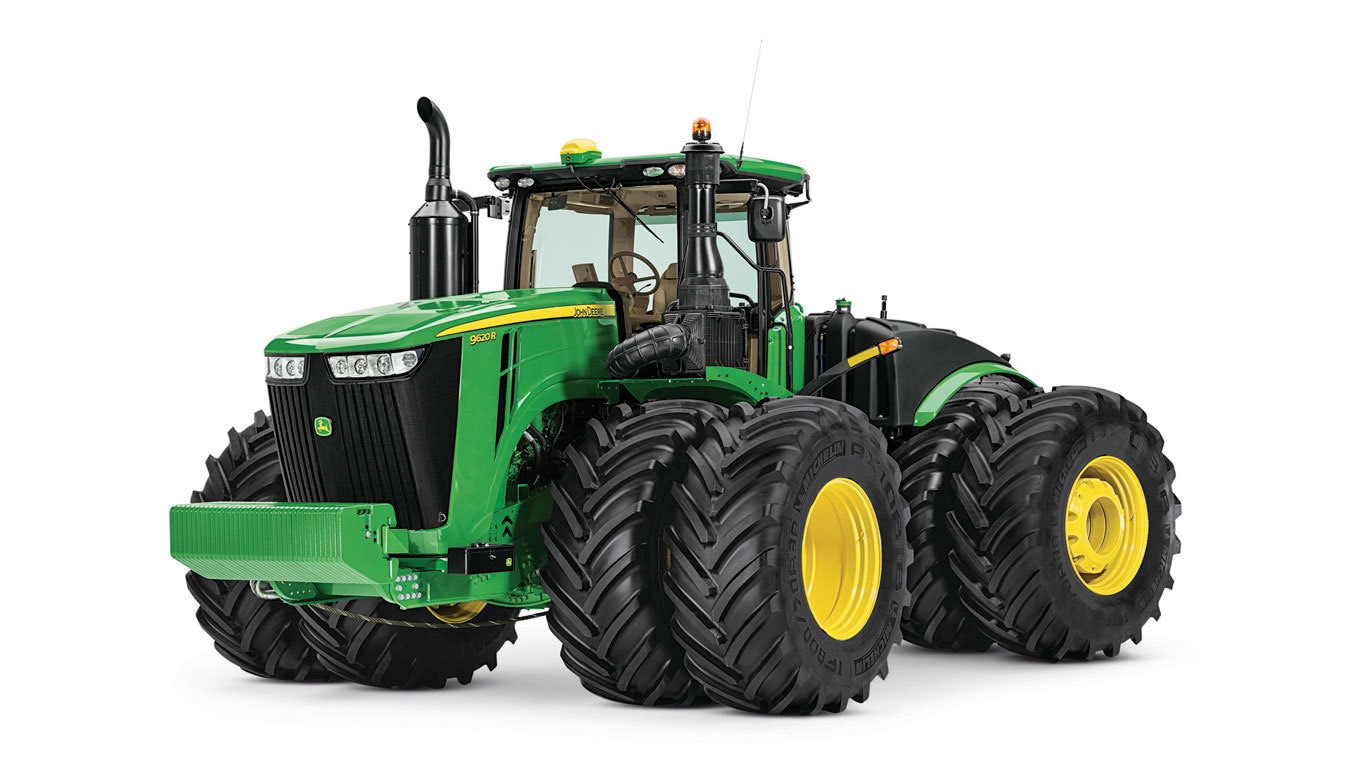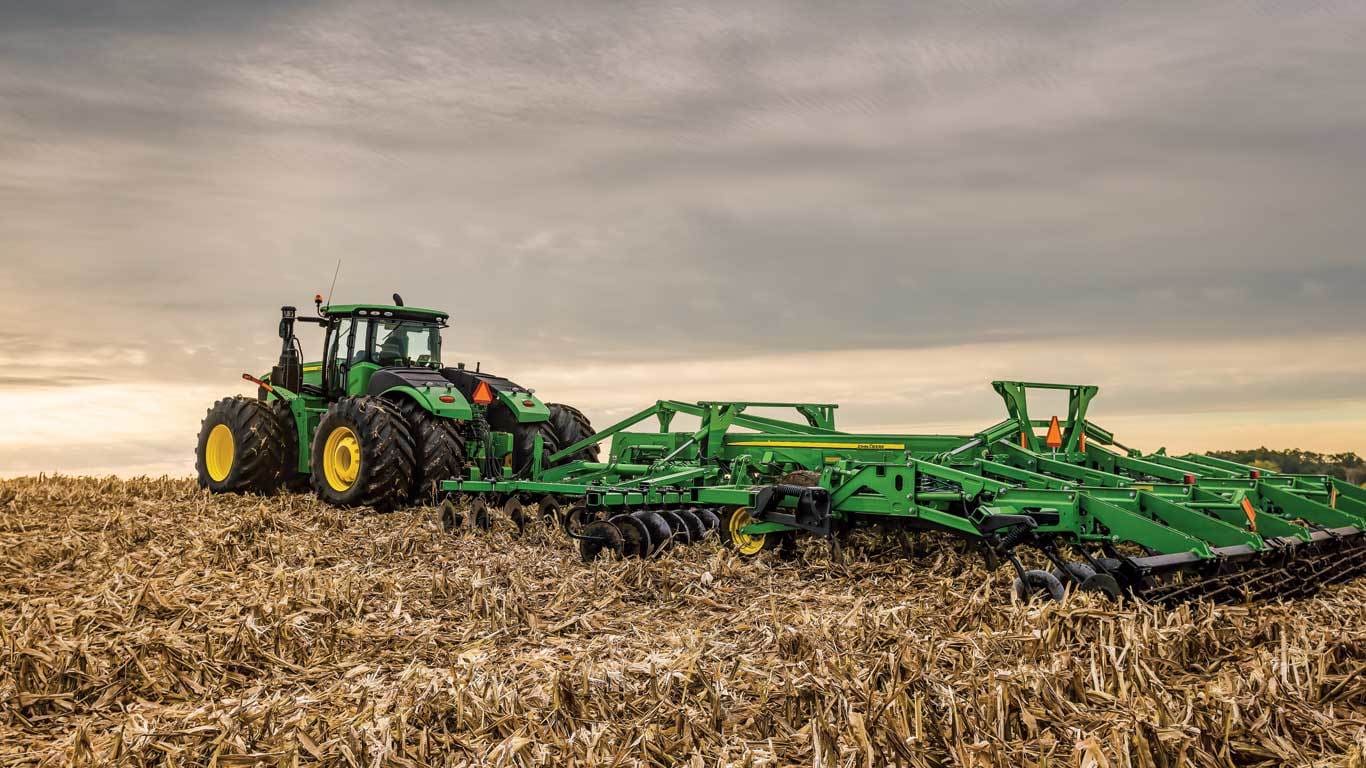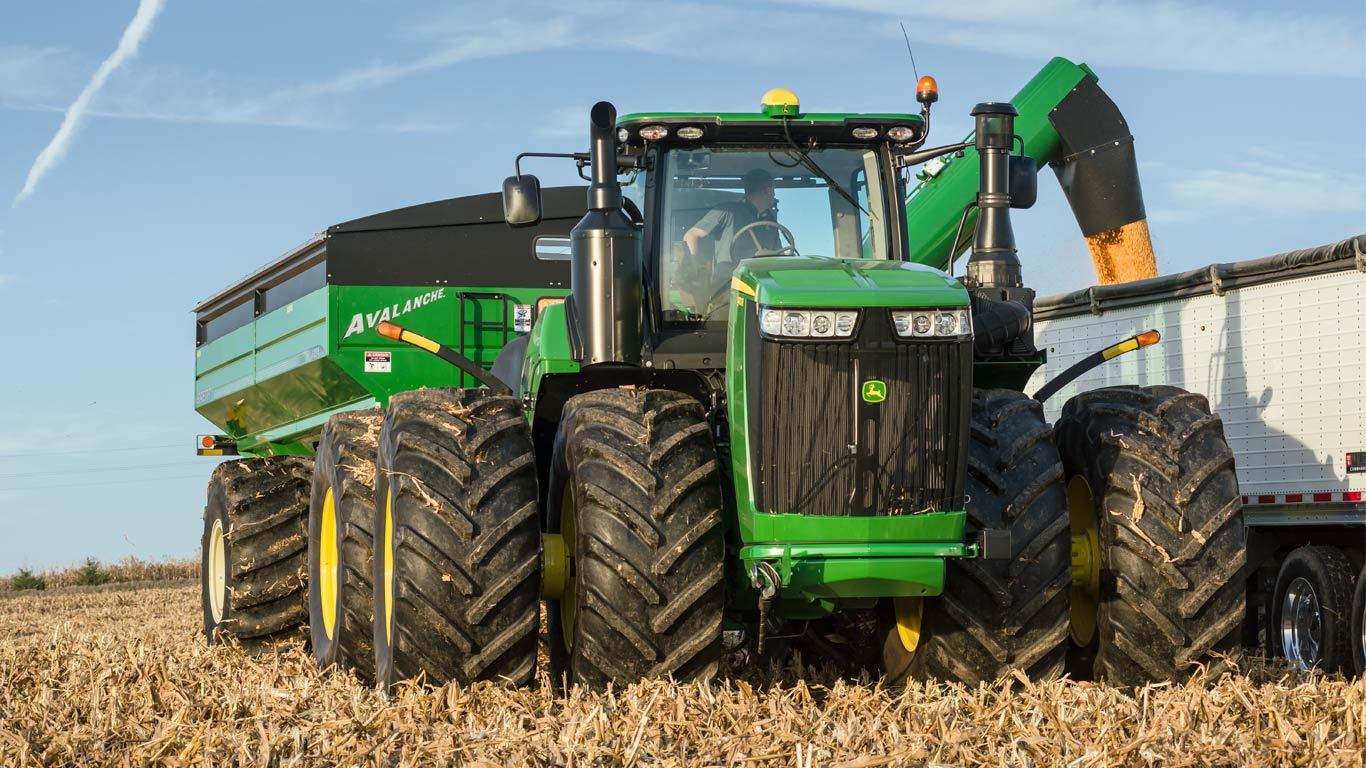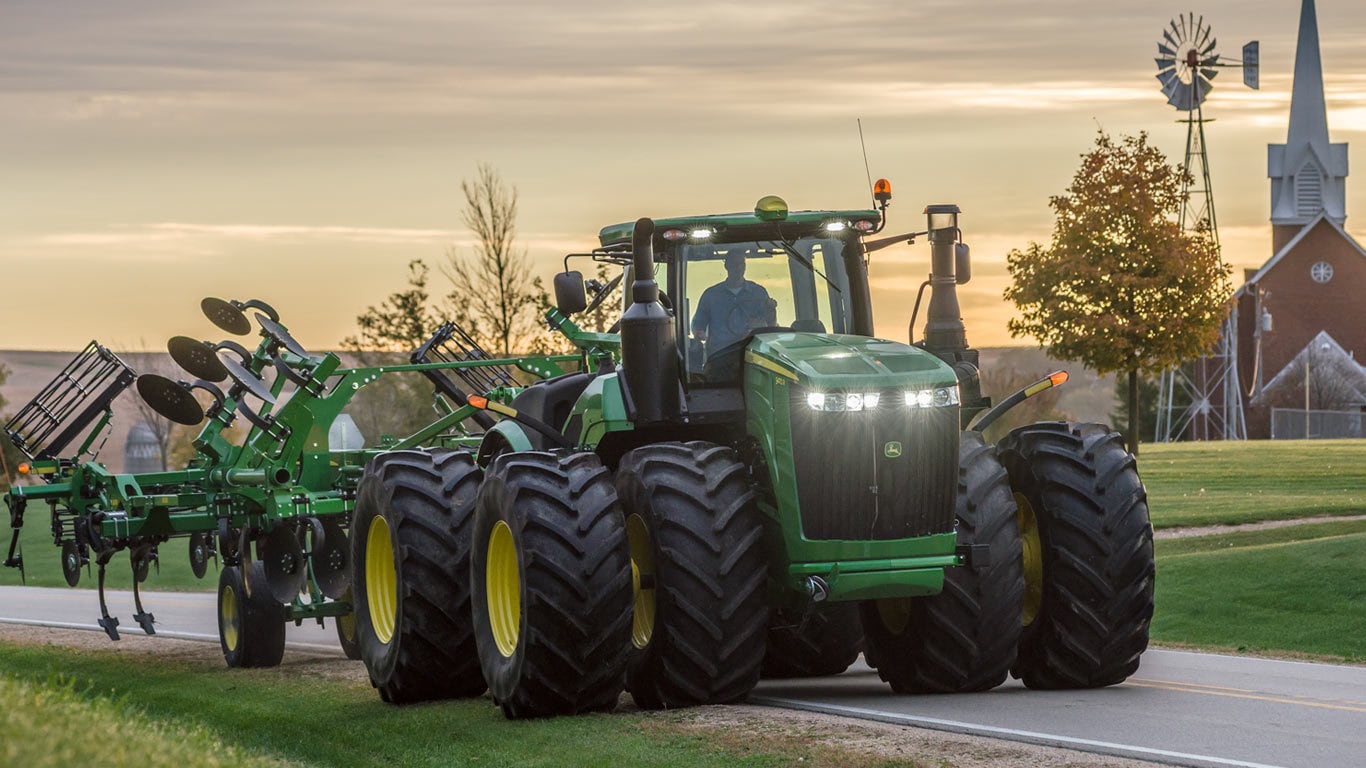Features
Off-highway electric powertrain experience
John Deere electric drivetrain components have more than one million hours of proven performance in the field. This new family of series-electric generator pump drives and traction drives offer a flexible, balanced, and scalable approach for electric drivetrain solutions.
– Seamless integration with John Deere engines, inverters, and drivetrain equipment
– Rugged components designed for high durability and reliability
– Modular configurations to fit a variety of applications
Features
Fixed geometry turbocharger
- Fixed geometry turbochargers are sized for a specific power range and optimized to provide excellent performance across the entire torque curve. They are also designed to maximize fuel economy between the engine's rated speed and peak torque.
Electronic unit pump (EUP) fuel system
- The EUI fuel system provides higher injection pressures up to 2,275 bar (33,000 psi). It also controls fuel injection timing and provides precise control for start, duration, and end of injection.
4-valve cylinder head
- The 4-valve cylinder head provides excellent airflow resulting in greater low-speed torque and better transient response time by utilizing a cross-flow design.
Air-to-air aftercooled
- This is the most efficient method of cooling intake air to help reduce engine emissions while maintaining low-speed torque, transient response time, and peak torque. It enables an engine to meet emissions regulations with better fuel economy and the lowest installed costs.
John Deere electronic engine controls
- Electronic engine controls monitor critical engine functions, providing warning and/or shutdown to prevent costly engine repairs and eliminate the need for add-on governing components, all lowering total installed costs.
Features
Fixed geometry turbocharger
- Fixed geometry turbochargers are sized for a specific power range and optimized to provide excellent performance across the entire torque curve. They are also designed to maximize fuel economy between the engine's rated speed and peak torque.
High pressure common rail (HPCR) fuel system
- The HPCR fuel system provides variable common-rail pressure, multiple injections, and higher injection pressures up to 1,600 bar (23,000 psi). It also controls fuel injection timing and provides precise control for the start, duration, and the end of injection.
4-valve cylinder head
- The 4-valve cylinder head provides excellent airflow by utilizing a U-flow design.
Air-to-air aftercooled
- This is the most efficient method of cooling intake air to help reduce engine emissions while maintaining low-speed torque, transient response time, and peak torque. It enables an engine to meet emissions regulations with better fuel economy and the lowest installed costs.
John Deere electronic engine controls
- Electronic engine controls monitor critical engine functions, providing warning and/or shutdown to prevent costly engine repairs and eliminate the need for add-on governing components, all lowering total installed costs.
Features
Dynamically balanced crankshaft
- Crankshafts are machined from a heat-treated, high carbon steel forging
Forged-steel connecting rods
- Unique 45-degree design permits the use of larger crankshaft connecting-rod bearings for increased durability
Self-adjusting poly-vee fan drive
- Self-adjusting, eight-groove, poly-vee fan drive provides multiple fan drive ratios and fan heights that can be matched to specific application requirements
- Poly-vee design provides more than twice the drive capacity of comparable vee-belts
Replaceable wet-type cylinder liners
- Provides excellent heat dissipation
- Precision machined for long life
Either-side service
- Engine installation and maintenance simplified and convenient by providing dipstick and oil filter options on both sides of the engine
Standard gear auxiliary drive
- Standard gear auxiliary drive produces up to 50 hp (37 kW) for gear-driven accessories
Mounting points
- Standard front and side mounting points provide easy installation and application flexibility
Features
Dynamically balanced crankshaft
- Crankshafts are formed from nodular iron
Forged-steel connecting rods
- Unique 45-degree design permits use of larger crankshaft connecting-rod bearings for increased durability
Self-adjusting poly-vee fan drive
- Self-adjusting, eight-groove, poly-vee fan drive provides multiple fan drive ratios and fan heights that can be matched to specific application requirements
- Poly-vee design provides more than twice the drive capacity of comparable vee-belts
Replaceable wet-type cylinder liners
- Provides excellent heat dissipation
- Precision machined for long life
Either-side service
- Engine installation and maintenance simplified and convenient by providing dipstick and oil filter options on both sides of the engine
Standard gear auxiliary drive
- Standard gear auxiliary drive produces up to 50 hp (37 kW) for gear-driven accessories
Mounting points
- Standard front and side mounting points provide easy installation and application flexibility
Optional engine-balancer shafts
- Provides smooth engine operation
Features
Dynamically balanced crankshaft
- Crankshafts are formed from nodular iron
Forged-steel connecting rods
- Unique 45-degree design permits use of larger crankshaft connecting-rod bearings for increased durability
Self-adjusting poly-vee fan drive
- Self-adjusting, eight-groove, poly-vee fan drive provides multiple fan drive ratios and fan heights that can be matched to specific application requirements
- Poly-vee design provides more than twice the drive capacity of comparable vee-belts
Replaceable wet-type cylinder liners
- Provides excellent heat dissipation
- Precision machined for long life
Either-side service
- Engine installation and maintenance simplified and convenient by providing dipstick and oil filter options on both sides of the engine
Standard gear auxiliary drive
- Standard gear auxiliary drive produces up to 50 hp (37 kW) for gear-driven accessories
Mounting points
- Standard front and side mounting points provide easy installation and application flexibility
Optional engine-balancer shafts
- Provides smooth engine operation
Features
Dynamically balanced crankshaft
- Journal surfaces induction-hardened for significantly increased wear life
Forged-steel connecting rods
- 45-degree connecting-rod/cap-joint design allows the use of larger crankshaft-connecting-rod bearings for increased durability
Replaceable wet-type cylinder liners
- Provides excellent heat dissipation
Strong cylinder block
- Weight of cylinder block reduced, while maintaining overall strength
- Crankshaft supported by four main bearings
Easy to apply
- Mounting points for new engine have not been changed, making it easy to replace previous model
- Additional front engine mounts are available for application ease
Compact size
- Compact, in-line 3-cylinder configuration allows model to be used in applications where length is critical
Optional gear auxiliary drive
- Optional drive, with an SAE "A" flange, increases application flexibility of the 3-cylinder engine
World-class performance
- Higher torque rise, excellent fuel economy, and low oil consumption result in superior engine performance
Features
Dynamically balanced crankshaft
- Journal surfaces induction-hardened for significantly increased wear life
Forged-steel connecting rods
- 45-degree connecting-rod/cap-joint design allows the use of larger crankshaft-connecting-rod bearings for increased durability
Replaceable wet-type cylinder liners
- Provides excellent heat dissipation
- Precision machined for long life
Strong cylinder block
- Weight of cylinder block reduced, while maintaining overall strength
- Crankshaft supported by four main bearings
Easy to apply
- Mounting points for new engine have not been changed, making it easy to replace previous model
- Additional front engine mounts are available for application ease
Compact size
- Compact, in-line 3-cylinder configuration allows model to be used in applications where length is critical
Optional gear auxiliary drive
- Optional drive, with an SAE "A" flange, increases application flexibility of the 3-cylinder engine
World-class performance
- Higher torque rise, excellent fuel economy, and low oil consumption result in superior engine performance
Features
Dynamically balanced crankshaft
- Crankshafts are machined from a heat-treated, high carbon steel forging
Forged-steel connecting rods
- Unique 45-degree design permits the use of larger crankshaft connecting-rod bearings for increased durability
Self-adjusting poly-vee fan drive
- Self-adjusting, eight-groove, poly-vee fan drive provides multiple fan drive ratios and fan heights that can be matched to specific application requirements
- Poly-vee design provides more than twice the drive capacity of comparable vee-belts
Replaceable wet-type cylinder liners
- Provides excellent heat dissipation
- Precision machined for long life
Either-side service
- Engine installation and maintenance simplified and convenient by providing dipstick and oil filter options on both sides of the engine
Standard gear auxiliary drive
- Standard gear auxiliary drive produces up to 50 hp (37 kW) for gear-driven accessories
Mounting points
- Standard front and side mounting points provide easy installation and application flexibility
Features
Dynamically balanced crankshaft
- Crankshafts are machined from a heat-treated, high carbon steel forging
Forged-steel connecting rods
- Unique 45-degree design permits the use of larger crankshaft connecting-rod bearings for increased durability
Self-adjusting poly-vee fan drive
- Self-adjusting, eight-groove, poly-vee fan drive provides multiple fan drive ratios and fan heights that can be matched to specific application requirements
- Poly-vee design provides more than twice the drive capacity of comparable vee-belts
Replaceable wet-type cylinder liners
- Provides excellent heat dissipation
- Precision machined for long life
Either-side service
- Engine installation and maintenance simplified and convenient by providing dipstick and oil filter options on both sides of the engine
Standard gear auxiliary drive
- Standard gear auxiliary drive produces up to 50 hp (37 kW) for gear-driven accessories
Mounting points
- Standard front and side mounting points provide easy installation and application flexibility
Features
Dynamically balanced crankshaft
- Crankshafts are machined from a heat-treated, high carbon steel forging
Forged-steel connecting rods
- Unique 45-degree design permits the use of larger crankshaft connecting-rod bearings for increased durability
Self-adjusting poly-vee fan drive
- Self-adjusting, eight-groove, poly-vee fan drive provides multiple fan drive ratios and fan heights that can be matched to specific application requirements
- Poly-vee design provides more than twice the drive capacity of comparable vee-belts
Replaceable wet-type cylinder liners
- Provides excellent heat dissipation
- Precision machined for long life
Either-side service
- Engine installation and maintenance simplified and convenient by providing dipstick and oil filter options on both sides of the engine
Standard gear auxiliary drive
- Standard gear auxiliary drive produces up to 50 hp (37 kW) for gear-driven accessories
Mounting points
- Standard front and side mounting points provide easy installation and application flexibility
Features
Dynamically balanced crankshaft
- Crankshafts are machined from a heat-treated, high carbon steel forging
Forged-steel connecting rods
- Unique 45-degree design permits the use of larger crankshaft connecting-rod bearings for increased durability
Self-adjusting poly-vee fan drive
- Self-adjusting, eight-groove, poly-vee fan drive provides multiple fan drive ratios and fan heights that can be matched to specific application requirements
- Poly-vee design provides more than twice the drive capacity of comparable vee-belts
Replaceable wet-type cylinder liners
- Provides excellent heat dissipation
- Precision machined for long life
Either-side service
- Engine installation and maintenance simplified and convenient by providing dipstick and oil filter options on both sides of the engine
Standard gear auxiliary drive
- Standard gear auxiliary drive produces up to 50 hp (37 kW) for gear-driven accessories
Mounting points
- Standard front and side mounting points provide easy installation and application flexibility
Features
Dynamically balanced crankshaft
- Crankshafts are machined from a heat-treated, high carbon steel forging
Forged-steel connecting rods
- Unique 45-degree design permits the use of larger crankshaft connecting-rod bearings for increased durability
Self-adjusting poly-vee fan drive
- Self-adjusting, eight-groove, poly-vee fan drive provides multiple fan drive ratios and fan heights that can be matched to specific application requirements
- Poly-vee design provides more than twice the drive capacity of comparable vee-belts
Replaceable wet-type cylinder liners
- Provides excellent heat dissipation
- Precision machined for long life
Either-side service
- Engine installation and maintenance simplified and convenient by providing dipstick and oil filter options on both sides of the engine
Standard gear auxiliary drive
- Standard gear auxiliary drive produces up to 50 hp (37 kW) for gear-driven accessories
Mounting points
- Standard front and side mounting points provide easy installation and application flexibility
Features
Dynamically balanced crankshaft
- Crankshafts are formed from nodular iron
Forged-steel connecting rods
- Unique 45-degree design permits use of larger crankshaft connecting-rod bearings for increased durability
Self-adjusting poly-vee fan drive
- Self-adjusting, eight-groove, poly-vee fan drive provides multiple fan drive ratios and fan heights that can be matched to specific application requirements
- Poly-vee design provides more than twice the drive capacity of comparable vee-belts
Replaceable wet-type cylinder liners
- Provides excellent heat dissipation
- Precision machined for long life
Either-side service
- Engine installation and maintenance simplified and convenient by providing dipstick and oil filter options on both sides of the engine
Standard gear auxiliary drive
- Standard gear auxiliary drive produces up to 50 hp (37 kW) for gear-driven accessories
Mounting points
- Standard front and side mounting points provide easy installation and application flexibility
Optional engine-balancer shafts
- Provides smooth engine operation
Features
Dynamically balanced crankshaft
- Crankshafts are formed from nodular iron
Forged-steel connecting rods
- Unique 45-degree design permits use of larger crankshaft connecting-rod bearings for increased durability
Self-adjusting poly-vee fan drive
- Self-adjusting, eight-groove, poly-vee fan drive provides multiple fan drive ratios and fan heights that can be matched to specific application requirements
- Poly-vee design provides more than twice the drive capacity of comparable vee-belts
Replaceable wet-type cylinder liners
- Provides excellent heat dissipation
- Precision machined for long life
Either-side service
- Engine installation and maintenance simplified and convenient by providing dipstick and oil filter options on both sides of the engine
Standard gear auxiliary drive
- Standard gear auxiliary drive produces up to 50 hp (37 kW) for gear-driven accessories
Mounting points
- Standard front and side mounting points provide easy installation and application flexibility
Optional engine-balancer shafts
- Provides smooth engine operation
Features
Dynamically balanced crankshaft
- Crankshafts are formed from nodular iron
Forged-steel connecting rods
- Unique 45-degree design permits use of larger crankshaft connecting-rod bearings for increased durability
Self-adjusting poly-vee fan drive
- Self-adjusting, eight-groove, poly-vee fan drive provides multiple fan drive ratios and fan heights that can be matched to specific application requirements
- Poly-vee design provides more than twice the drive capacity of comparable vee-belts
Replaceable wet-type cylinder liners
- Provides excellent heat dissipation
- Precision machined for long life
Either-side service
- Engine installation and maintenance simplified and convenient by providing dipstick and oil filter options on both sides of the engine
Standard gear auxiliary drive
- Standard gear auxiliary drive produces up to 50 hp (37 kW) for gear-driven accessories
Mounting points
- Standard front and side mounting points provide easy installation and application flexibility
Optional engine-balancer shafts
- Provides smooth engine operation
Features
Dynamically balanced crankshaft
- Crankshafts are formed from nodular iron
Forged-steel connecting rods
- Unique 45-degree design permits use of larger crankshaft connecting-rod bearings for increased durability
Self-adjusting poly-vee fan drive
- Self-adjusting, eight-groove, poly-vee fan drive provides multiple fan drive ratios and fan heights that can be matched to specific application requirements
- Poly-vee design provides more than twice the drive capacity of comparable vee-belts
Replaceable wet-type cylinder liners
- Provides excellent heat dissipation
- Precision machined for long life
Either-side service
- Engine installation and maintenance simplified and convenient by providing dipstick and oil filter options on both sides of the engine
Standard gear auxiliary drive
- Standard gear auxiliary drive produces up to 50 hp (37 kW) for gear-driven accessories
Mounting points
- Standard front and side mounting points provide easy installation and application flexibility
Optional engine-balancer shafts
- Provides smooth engine operation
Features
Meets epa, carb, and eu off-road emission regulations
- Engine developed to meet off-road emission requirements without degradation in performance or power level
Dynamically balanced crankshaft
- Journal surfaces induction-hardened for significantly increased wear life
Forged-steel connecting rods
- 45-degree connecting-rod/cap-joint design allows the use of larger crankshaft-connecting-rod bearings for increased durability
Replaceable wet-type cylinder liners
- Provides excellent heat dissipation
Strong cylinder block
- Weight of cylinder block reduced, while maintaining overall strength
- Crankshaft supported by four main bearings
Easy to apply
- Mounting points for new engine have not been changed, making it easy to replace previous model
- Additional front engine mounts are available for application ease
Compact size
- Compact, in-line 3-cylinder configuration allows model to be used in applications where length is critical
Optional gear auxiliary drive
- Optional drive, with an SAE "A" flange, increases application flexibility of the 3-cylinder engine
World-class performance
- Higher torque rise, excellent fuel economy, and low oil consumption result in superior engine performance
Features
Meets epa, carb, and eu off-road emission regulations
- Engine developed to meet off-road emission requirements without degradation in performance or power level
Dynamically balanced crankshaft
- Journal surfaces induction-hardened for significantly increased wear life
Forged-steel connecting rods
- 45-degree connecting-rod/cap-joint design allows the use of larger crankshaft-connecting-rod bearings for increased durability
Replaceable wet-type cylinder liners
- Provides excellent heat dissipation
- Precision machined for long life
Strong cylinder block
- Weight of cylinder block reduced, while maintaining overall strength
- Crankshaft supported by four main bearings
Easy to apply
- Mounting points for new engine have not been changed, making it easy to replace previous model
- Additional front engine mounts are available for application ease
Compact size
- Compact, in-line 3-cylinder configuration allows model to be used in applications where length is critical
Optional gear auxiliary drive
- Optional drive, with an SAE "A" flange, increases application flexibility of the 3-cylinder engine
World-class performance
- Higher torque rise, excellent fuel economy, and low oil consumption result in superior engine performance
Features
Dynamically balanced crankshaft
- Crankshafts are machined from a heat-treated, high carbon steel forging
Forged-steel connecting rods
- Unique 45-degree design permits the use of larger crankshaft connecting-rod bearings for increased durability
Self-adjusting poly-vee fan drive
- Self-adjusting, eight-groove, poly-vee fan drive provides multiple fan drive ratios and fan heights that can be matched to specific application requirements
- Poly-vee design provides more than twice the drive capacity of comparable vee-belts
Replaceable wet-type cylinder liners
- Provides excellent heat dissipation
- Precision machined for long life
Either-side service
- Engine installation and maintenance simplified and convenient by providing dipstick and oil filter options on both sides of the engine
500-hour oil change
- Customers save significant costs on oil, filters and labor with a 500-hour oil change interval
Standard gear auxiliary drive
- Standard gear auxiliary drive produces up to 50 hp (37 kW) for gear-driven accessories
Mounting points
- Standard front and side mounting points provide easy installation and application flexibility
Electronic-controlled rotary injection pump
- Electronic-controlled rotary injection pump distributes the precise amount of fuel required by each cylinder at exactly the right time
- Electronic controls monitor engine speed and load to determine fuel timing
SAE J1939 standard communication link
- Industry standard, which provides an interface with vehicle systems, like the transmission, hydraulics and various accessory drives minimizing machine complexity and reducing the installed cost
Features
Dynamically balanced crankshaft
- Crankshafts are machined from a heat-treated, high carbon steel forging
Forged-steel connecting rods
- Unique 45-degree design permits the use of larger crankshaft connecting-rod bearings for increased durability
Self-adjusting poly-vee fan drive
- Self-adjusting, eight-groove, poly-vee fan drive provides multiple fan drive ratios and fan heights that can be matched to specific application requirements
- Poly-vee design provides more than twice the drive capacity of comparable vee-belts
Replaceable wet-type cylinder liners
- Provides excellent heat dissipation
- Precision machined for long life
Either-side service
- Engine installation and maintenance simplified and convenient by providing dipstick and oil filter options on both sides of the engine
500-Hour oil change
- Customers save significant costs on oil, filters and labor with a 500-hour oil change interval
Standard gear auxiliary drive
- Standard gear auxiliary drive produces up to 50 hp (37 kW) for gear-driven accessories
Mounting points
- Standard front and side mounting points provide easy installation and application flexibility
Electronic-controlled rotary injection pump
- Electronic-controlled rotary injection pump distributes the precise amount of fuel required by each cylinder at exactly the right time
- Electronic controls monitor engine speed and load to determine fuel timing
SAE J1939 standard communication link
- Industry standard, which provides an interface with vehicle systems, like the transmission, hydraulics and various accessory drives minimizing machine complexity and reducing the installed cost
Features
Dynamically balanced crankshaft
- Crankshafts are machined from a heat-treated, high carbon steel forging
Forged-steel connecting rods
- Unique 45-degree design permits the use of larger crankshaft connecting-rod bearings for increased durability
Self-adjusting poly-vee fan drive
- Self-adjusting, eight-groove, poly-vee fan drive provides multiple fan drive ratios and fan heights that can be matched to specific application requirements
- Poly-vee design provides more than twice the drive capacity of comparable vee-belts
Replaceable wet-type cylinder liners
- Provides excellent heat dissipation
- Precision machined for long life
Either-side service
- Engine installation and maintenance simplified and convenient by providing dipstick and oil filter options on both sides of the engine
500-Hour oil change
- Customers save significant costs on oil, filters and labor with a 500-hour oil change interval
Standard gear auxiliary drive
- Standard gear auxiliary drive produces up to 50 hp (37 kW) for gear-driven accessories
Mounting points
- Standard front and side mounting points provide easy installation and application flexibility
Electronic-controlled rotary injection pump
- Electronic-controlled rotary injection pump distributes the precise amount of fuel required by each cylinder at exactly the right time
- Electronic controls monitor engine speed and load to determine fuel timing
SAE J1939 standard communication link
- Industry standard, which provides an interface with vehicle systems, like the transmission, hydraulics and various accessory drives minimizing machine complexity and reducing the installed cost
Features
Dynamically balanced crankshaft
- Crankshafts are formed from nodular iron
Forged-steel connecting rods
- Unique 45-degree design permits use of larger crankshaft connecting-rod bearings for increased durability
Self-adjusting poly-vee fan drive
- Self-adjusting, eight-groove, poly-vee fan drive provides multiple fan drive ratios and fan heights that can be matched to specific application requirements
- Poly-vee design provides more than twice the drive capacity of comparable vee-belts
Replaceable wet-type cylinder liners
- Provides excellent heat dissipation
- Precision machined for long life
Either-side service
- Engine installation and maintenance simplified and convenient by providing dipstick and oil filter options on both sides of the engine
500-Hour oil change
- Customers save significant costs on oil, filters and labor with a 500-hour oil change interval
Standard gear auxiliary drive
- Standard gear auxiliary drive produces up to 50 hp (37 kW) for gear-driven accessories
Mounting points
- Standard front and side mounting points provide easy installation and application flexibility
Electronic-controlled rotary injection pump
- Electronic-controlled rotary injection pump distributes the precise amount of fuel required by each cylinder at exactly the right time
- Electronic controls monitor engine speed and load to determine fuel timing
SAE J1939 standard communication link
- Industry standard, which provides an interface with vehicle systems, like the transmission, hydraulics and various accessory drives minimizing machine complexity and reducing the installed cost
Optional engine-balancer shafts
- Provides smooth engine operation
Features
Dynamically balanced crankshaft
- Crankshafts are formed from nodular iron
Forged-steel connecting rods
- Unique 45-degree design permits use of larger crankshaft connecting-rod bearings for increased durability
Self-adjusting poly-vee fan drive
- Self-adjusting, eight-groove, poly-vee fan drive provides multiple fan drive ratios and fan heights that can be matched to specific application requirements
- Poly-vee design provides more than twice the drive capacity of comparable vee-belts
Replaceable wet-type cylinder liners
- Provides excellent heat dissipation
- Precision machined for long life
Either-side service
- Engine installation and maintenance simplified and convenient by providing dipstick and oil filter options on both sides of the engine
500-Hour oil change
- Customers save significant costs on oil, filters and labor with a 500-hour oil change interval
Standard gear auxiliary drive
- Standard gear auxiliary drive produces up to 50 hp (37 kW) for gear-driven accessories
Mounting points
- Standard front and side mounting points provide easy installation and application flexibility
Optional engine-balancer shafts
- Provides smooth engine operation
Features
Dynamically balanced crankshaft
- Crankshafts are formed from nodular iron
Forged-steel connecting rods
- Unique 45-degree design permits use of larger crankshaft connecting-rod bearings for increased durability
Self-adjusting poly-vee fan drive
- Self-adjusting, eight-groove, poly-vee fan drive provides multiple fan drive ratios and fan heights that can be matched to specific application requirements
- Poly-vee design provides more than twice the drive capacity of comparable vee-belts
Replaceable wet-type cylinder liners
- Provides excellent heat dissipation
- Precision machined for long life
Either-side service
- Engine installation and maintenance simplified and convenient by providing dipstick and oil filter options on both sides of the engine
500-Hour oil change
- Customers save significant costs on oil, filters and labor with a 500-hour oil change interval
Standard gear auxiliary drive
- Standard gear auxiliary drive produces up to 50 hp (37 kW) for gear-driven accessories
Mounting points
- Standard front and side mounting points provide easy installation and application flexibility
Electronic-controlled rotary injection pump
- Electronic-controlled rotary injection pump distributes the precise amount of fuel required by each cylinder at exactly the right time
- Electronic controls monitor engine speed and load to determine fuel timing
SAE J1939 standard communication link
- Industry standard, which provides an interface with vehicle systems, like the transmission, hydraulics and various accessory drives minimizing machine complexity and reducing the installed cost
Optional engine-balancer shafts
- Provides smooth engine operation
Features
Dynamically balanced crankshaft
- Crankshafts are formed from nodular iron
Forged-steel connecting rods
- Unique 45-degree design permits use of larger crankshaft connecting-rod bearings for increased durability
Self-adjusting poly-vee fan drive
- Self-adjusting, eight-groove, poly-vee fan drive provides multiple fan drive ratios and fan heights that can be matched to specific application requirements
- Poly-vee design provides more than twice the drive capacity of comparable vee-belts
Replaceable wet-type cylinder liners
- Provides excellent heat dissipation
- Precision machined for long life
Either-side service
- Engine installation and maintenance simplified and convenient by providing dipstick and oil filter options on both sides of the engine.
500-Hour oil change
- Customers save significant costs on oil, filters and labor with a 500-hour oil change interval
Standard gear auxiliary drive
- Standard gear auxiliary drive produces up to 50 hp (37 kW) for gear-driven accessories
Mounting points
Standard front and side mounting points provide easy installation and application flexibility
Electronic-controlled rotary injection pump
- Electronic-controlled rotary injection pump distributes the precise amount of fuel required by each cylinder at exactly the right time
- Electronic controls monitor engine speed and load to determine fuel timing
SAE J1939 standard communication link
- Industry standard, which provides an interface with vehicle systems, like the transmission, hydraulics and various accessory drives minimizing machine complexity and reducing the installed cost
Optional engine-balancer shafts
- Provides smooth engine operation
Features
Dynamically balanced crankshaft
- Crankshafts are formed from nodular iron
Forged-steel connecting rods
- Unique 45-degree design permits use of larger crankshaft connecting-rod bearings for increased durability
Self-adjusting poly-vee fan drive
- Self-adjusting, eight-groove, poly-vee fan drive provides multiple fan drive ratios and fan heights that can be matched to specific application requirements
- Poly-vee design provides more than twice the drive capacity
Replaceable wet-type cylinder liners
- Provides excellent heat dissipation
- Precision machined for long life
Either-side service
- Engine installation and maintenance simplified and convenient by providing dipstick and oil filter options on both sides of the engine
500-Hour oil change
- Customers save significant costs on oil, filters and labor with a 500-hour oil change interval
Standard gear auxiliary drive
- Standard gear auxiliary drive produces up to 50 hp (37 kW) for gear-driven accessories
Mounting points
- Standard front and side mounting points provide easy installation and application flexibility
Optional engine-balancer shafts
- Provides smooth engine operation
Features
Series turbocharger
- Fresh air is first drawn into the low-pressure turbocharger (fixed geometry) and compressed to a higher pressure. The compressed air is then drawn into the high-pressure turbocharger (VGT), where the air is further compressed. The high-pressure air is then routed through a charge air cooler and into the engine's intake manifold. By splitting the work between two turbochargers, both can operate at peak efficiency and at slower rotating speeds — lowering stress on turbocharger components and improving reliability. Series turbocharging delivers more boost pressure than single turbocharger configurations, which results in higher power density, improved low-speed torque, and improved high altitude operation.
Cooled exhaust gas recirculation (EGR)
- EGR cools and mixes measured amounts of cooled exhaust gas with incoming fresh air to lower peak combustion temperatures, thereby reducing NOx.
Electronic unit injectors (EUI) and engine control unit (ECU)
- The EUI fuel system provides higher injection pressures up to 2,275 bar (33,000 psi). One ECU controls the exhaust filter, as well as fuel system and provides precise control for the start, duration, and end of injection.
Exhaust filters
- These engines utilize a catalyzed exhaust filter that contains a diesel oxidation catalyst (DOC) and a diesel particulate filter (DPF). The DOC reacts with exhaust gases to reduce carbon monoxide, hydrocarbons, and some particulate matter (PM). The downstream DPF traps and holds the remaining PM. Trapped particles are oxidized within the DPF through a continuous cleaning process called passive regeneration. Passive regeneration occurs during normal operating conditions when heat from the exhaust stream and catalysts within the exhaust filter trigger the oxidation of the trapped PM. If passive regeneration cannot be achieved due to low temperature, load, or speed, then PM is removed using active regeneration — an automatic cleaning process controlled by the exhaust temperature management system.
4-valve cylinder head
- The 4-valve cylinder head provides excellent airfow resulting in greater low-speed torque and better transient response time by utilizing a cross-flow design.
Air-to-air aftercooled
- This is the most efficient method of cooling intake air to help reduce engine emissions. It enables an engine to meet emissions regulations with better fuel economy and the lowest installed costs.
Engine performance
- Multiple rated speeds to further reduce noise and improve fuel economy
- Higher level of peak torque
- Optional power bulge
Compact size
- Lower installed cost
- Simplifies installation
- Mounting points are the same as previous engine models
Additional features
- 500-hour oil change
- Self-adjusting poly-vee fan drive
- Variable-speed fan drive increases fuel economy and decreases noise levels
- Single-piece low-friction steel piston
- Directed top-liner cooling
- Low-pressure fuel system with electrical transfer pump and "auto-prime" feature
Features
Series turbocharger
- Fresh air is first drawn into the low-pressure turbocharger (fixed geometry) and compressed to a higher pressure. The compressed air is then drawn into the high-pressure turbocharger (VGT), where the air is further compressed.The high-pressure air is then routed through a charge air cooler and into the engine's intake manifold.
- By splitting the work between two turbochargers, both can operate at peak efficiency and at slower rotating speeds — lowering stress on turbocharger components and improving reliability. Series turbocharging delivers more boost pressure than single turbocharger configurations which results in higher power density, improved low-speed torque, and improved high altitude operation.
High-pressure common-rail (HPCR) and engine control unit (ECU)
- The HPCR fuel system provides variable common-rail pressure, multiple injections, and higher injection pressures up to 1,975 bar (29,000 psi). It also controls fuel injection timing and provides precise control for the start, duration, and end of injection.
Cooled exhaust gas recirculation (EGR)
- EGR cools and mixes measured amounts of cooled exhaust gas with incoming fresh air to lower peak combustion temperatures, thereby reducing NOx.
Exhaust filters
- These engines utilize a catalyzed exhaust filter that contains a diesel oxidation catalyst (DOC) and a diesel particulate filter (DPF). The DOC reacts with exhaust gases to reduce carbon monoxide, hydrocarbons, and some particulate matter (PM). The downstream DPF traps and holds the remaining PM. Trapped particles are oxidized within the DPF through a continuous cleaning process called passive regeneration.
- Passive regeneration occurs during normal operating conditions when heat from the exhaust stream and catalysts within the exhaust filter trigger the oxidation of the trapped PM. If passive regeneration cannot be achieved due to low temperature, load, or speed, then PM is removed using active regeneration — an automatic cleaning process controlled by the exhaust temperature management system.
4-valve cylinder head
- The 4-valve cylinder head provides excellent airflow resulting in greater low-speed torque and better transient response time by utilizing a U-flow design.
Air-to-air aftercooled
- This is the most efficient method of cooling intake air to help reduce engine emissions while maintaining low-speed torque, transient response time, and peak torque. It enables an engine to meet emissions regulations with better fuel economy and the lowest installed costs.
Engine performance
- Multiple rated speeds to further reduce noise and improve fuel economy; higher level of peak torque; transient response time equal to or better than Tier 3/Stage III A; low-speed torque equal to or better than Tier 3/Stage III A
Compact size
- Lower installed cost; mounting points are the same as previous engine models
John Deere electronic engine controls
- Faster engine control unit (ECU) manages both the engine and the exhaust filter; full authority electronic controls; four times the memory, twice the RAM and double the processing speed; the input/output capability has increased 40%
Additional features
- Gear-driven auxiliary drives
- 500-hour oil change
- Self-adjusting poly-vee fan drive
- Single-piece low-friction piston
- Directed top-liner cooling
- Low-pressure fuel system with electrical transfer pump and "auto-prime" feature
- Optional rear PTO
Features
Variable geometry turbocharger
- Varies exhaust pressure based on load and speed to ensure proper EGR flow. The combination of the cooled EGR and VGT provide low-speed torque, quicker transient response, higher-peak torque, and world-class fuel economy.
High-pressure common-rail (HPCR) and engine control unit (ECU)
- The HPCR fuel system provides variable common-rail pressure, multipe injections, and higher injection pressures up to 1,975 bar (29,000 psi). One ECU controls the exhaust filter, as well as fuel system and provides precise control for the start, duration, and end of injection.
Cooled exhaust gas recirculation (EGR)
- EGR cools and mixes measured amounts of cooled exhaust gas with incoming fresh air to lower peak combustion temperatures, thereby reducing NOx.
4-valve cylinder head
- The 4-valve cylinder head provides excellent airflow resulting in greater low-speed torque and better transient response time by utilizing a U-flow design.
Air-to-air aftercooled
- This is the most efficient method of cooling intake air to help reduce engine emissions while maintaining low-speed torque, transient response time, and peak torque. It enables an engine to meet emissions regulations with better fuel economy and the lowest installed costs.
Exhaust filters
- These engines utilize a catalyzed exhaust filter that contains a diesel oxidation catalyst (DOC) and a diesel particulate filter (DPF). The DOC reacts with exhaust gases to reduce carbon monoxide, hydrocarbons, and some particulate matter (PM). The downstream DPF traps and holds the remaining PM. Trapped particles are oxidized within the DPF through a continuous cleaning process called passive regeneration.
- Passive regeneration occurs during normal operating conditions when heat from the exhaust stream and catalysts within the exhaust filter trigger the oxidation of the trapped PM. If passive regeneration cannot be achieved due to low temperature, load, or speed, then PM is removed using active regeneration — an automatic cleaning process controlled by the exhaust temperature management system.
Engine performance
- Multiple rated speeds to further reduce noise and improve fuel economy
- Higher level of peak torque
- Optional bower bulge
Compact size
- Lower installed cost
- Mounting points are the same as previous engine models
Additional features
- JDLink™ lets you monitor, protect, and maintain your equipment 24/7
- Premium software option integrates with equipment or vehicles to reduce engineering and installation costs
- 500-hour oil change
- Optional factory installed variable-speed fan drive improves fuel economy and reduces noise levels
- Low-pressure fuel system with electrical transfer pump and "auto prime" feature
Features
Series turbocharger
- Fresh air is first drawn into the low-pressure turbocharger (fixed geometry) and compressed to a higher pressure. The compressed air is then drawn into the high-pressure turbocharger (VGT), where the air is further compressed. The high-pressure air is then routed through a charge air cooler and into the engine’s intake manifold.
- By splitting the work between two turbochargers, both can operate at peak efficiency and at slower rotating speeds — lowering stress on turbocharger components and improving reliability. Series turbocharging delivers more boost pressure than single turbocharger configurations, which results in higher power density, improved low-speed torque, and improved high altitude operation.
High-pressure common-rail (HPCR) and engine control unit (ECU)
- The HPCR fuel system provides variable common-rail pressure, multiple injections, and higher injection pressures up to 1,975 bar (29,000 psi). It also controls fuel injection timing and provides precise control for the start, duration, and end of injection.
Cooled exhaust gas recirculation (EGR)
- EGR cools and mixes measured amounts of cooled exhaust gas with incoming fresh air to lower peak combustion temperatures, thereby reducing NOx.
4-valve cylinder head
- The 4-valve cylinder head provides excellent airflow resulting in greater low-speed torque and better transient response time by utilizing a U-flow design.
Air-to-air aftercooled
- This is the most efficient method of cooling intake air to help reduce engine emissions while maintaining low-speed torque, transient response time, and peak torque. It enables an engine to meet emissions regulations with better fuel economy and the lowest installed costs.
Exhaust filters
- These engines utilize a catalyzed exhaust filter that contains a diesel oxidation catalyst (DOC) and a diesel particulate filter (DPF). The DOC reacts with exhaust gases to reduce carbon monoxide, hydrocarbons, and some particulate matter (PM). The downstream DPF traps and holds the remaining PM. Trapped particles are oxidized within the DPF through a continuous cleaning process called passive regeneration.
- Passive regeneration occurs during normal operating conditions when heat from the exhaust stream and catalysts within the exhaust filter trigger the oxidation of the trapped PM. If passive regeneration cannot be achieved due to low temperature, load, or speed, then PM is removed using active regeneration — an automatic cleaning process controlled by the exhaust temperature management system. Engines below 130 kW (174 hp) use an in-cylinder dosing system for active regeneration, while larger engines use an external dosing system.
Engine performance
- Faster engine control unit (ECU) manages both the engine and the exhaust filter; full authority electronic controls; four times the memory, twice the RAM, and double the processing speed; the input/output capability has increased 40%
Compact size
- Lower installed cost; simplifies installation; mounting points are the same as previous engine models
Additional features
- Glow plugs
- 500-hour oil change
- Self-adjusting poly-vee fan drive
- Variable-speed fan drive increases fuel economy and decreases noise levels
- R.H. and L.H. engine-mounted final fuel filters
- Low-pressure fuel system with electrical transfer pump and "auto-prime" feature
- Directed top-liner cooling
Features
Engine performance
- Multiple rated speeds to further reduce noise and improve fuel economy
- Higher level of peak torque
- Optional power bulge
Cooled exhaust gas recirculation (EGR)
- EGR cools and mixes measured amounts of cooled exhaust gas with incoming fresh air to lower peak combustion temperatures, thereby reducing NOx.
Variable geometry turbocharger
- Varies exhaust pressure based on load and speed to ensure proper EGR flow. The combination of the cooled EGR and VGT provide low-speed torque, quicker transient response, higher-peak torque, and world-class fuel economy.
High-pressure common-rail (HPCR) and engine control unit (ECU)
- The HPCR fuel system provides variable common-rail pressure and higher injection pressures up to 1,975 bar (29,000 psi).One ECU controls the exhaust filter, as well as fuel system and provides precise control for the start, duration, and end of injection.
4-valve cylinder head
- The 4-valve cylinder head provides excellent airflow resulting in greater low-speed torque and better transient response time by utilizing a cross-flow design.
Air-to-air aftercooled
- This is the most efficient method of cooling intake air to help reduce engine emissions while maintaining low-speed torque, transient response time, and peak torque. It enables an engine to meet emissions regulations with better fuel economy and the lowest installed costs.
Exhaust filters
- These engines utilize a catalyzed exhaust filter that contains a diesel oxidation catalyst (DOC) and a diesel particulate filter (DPF). The DOC reacts with exhaust gases to reduce carbon monoxide, hydrocarbons, and some particulate matter (PM). The downstream DPF traps and holds the remaining PM. Trapped particles are oxidized within the DPF through a continuous cleaning process called passive regeneration.
- Passive regeneration occurs during normal operating conditions when heat from the exhaust stream and catalysts within the exhaust filter trigger the oxidation of the trapped PM. If passive regeneration cannot be achieved due to low temperature, load, or speed, then PM is removed using active regeneration — an automatic cleaning process controlled by the exhaust temperature management system.
Compact size
- Lower installed cost
- Mounting points are the same as previous engine models
Additional features
- JDLink™ lets you monitor, protect, and maintain your equipment 24/7
- Premium software option integrates with equipment or vehicles to reduce engineering and installation costs
- 500-hour oil change
- Optional factory installed variable-speed fan drive improves fuel economy and reduces noise levels
- R.H. and L.H. engine-mounted final fuel filters
- Low-pressure fuel system with electrical transfer pump and "auto-prime" feature
Features
Engine performance
- Multiple rated speeds to further reduce noise and improve fuel economy
- Higher level of peak torque
- Optional power bulge
Cooled exhaust gas recirculation (EGR)
- EGR cools and mixes measured amounts of cooled exhaust gas with incoming fresh air to lower peak combustion temperatures, thereby reducing NOx.
Variable geometry turbocharger
- Varies exhaust pressure based on load and speed to ensure proper EGR flow. The combination of the cooled EGR and VGT provide low-speed torque, quicker transient response, higher-peak torque, and world-class fuel economy.
High-pressure common-rail (HPCR) and engine control unit (ECU)
- The HPCR fuel system provides variable common-rail pressure and higher injection pressures up to 1,975 bar (29,000 psi).One ECU controls the exhaust filter, as well as fuel system and provides precise control for the start, duration, and end of injection.
4-valve cylinder head
- The 4-valve cylinder head provides excellent airflow resulting in greater low-speed torque and better transient response time by utilizing a cross-flow design.
Air-to-air aftercooled
- This is the most efficient method of cooling intake air to help reduce engine emissions while maintaining low-speed torque, transient response time, and peak torque. It enables an engine to meet emissions regulations with better fuel economy and the lowest installed costs.
Exhaust filters
- These engines utilize a catalyzed exhaust filter that contains a diesel oxidation catalyst (DOC) and a diesel particulate filter (DPF). The DOC reacts with exhaust gases to reduce carbon monoxide, hydrocarbons, and some particulate matter (PM). The downstream DPF traps and holds the remaining PM. Trapped particles are oxidized within the DPF through a continuous cleaning process called passive regeneration.
- Passive regeneration occurs during normal operating conditions when heat from the exhaust stream and catalysts within the exhaust filter trigger the oxidation of the trapped PM. If passive regeneration cannot be achieved due to low temperature, load, or speed, then PM is removed using active regeneration — an automatic cleaning process controlled by the exhaust temperature management system.
Compact size
- Lower installed cost
- Mounting points are the same as previous engine models
Additional features
- JDLink™ lets you monitor, protect, and maintain your equipment 24/7
- Premium software option integrates with equipment or vehicles to reduce engineering and installation costs
- 500-hour oil change
- Optional factory installed variable-speed fan drive improves fuel economy and reduces noise levels
- R.H. and L.H. engine-mounted final fuel filters
- Low-pressure fuel system with electrical transfer pump and "auto-prime" feature
Features
Variable geometry turbocharger (VGT)
- Varies exhaust pressure based on load and speed to ensure proper EGR flow. The combination of the cooled EGR and VGT provide low-speed torque, quicker transient response, higher-peak torque, and world-class fuel economy.
Cooled exhaust gas recirculation (EGR)
- EGR cools and mixes measured amounts of cooled exhaust gas with incoming fresh air to lower peak combustion temperatures, thereby reducing Nox.
Exhaust filters
- These engines utilize a catalyzed exhaust filter that contains a diesel oxidation catalyst (DOC) and a diesel particulate filter (DPF). The DOC reacts with exhaust gases to reduce carbon monoxide, hydrocarbons, and some particulate matter (PM). The downstream DPF traps and holds the remaining PM. Trapped particles are oxidized within the DPF through a continuous cleaning process called passive regeneration. Passive regeneration occurs during normal operating conditions when heat from the exhaust stream and catalysts within the exhaust filter trigger the oxidation of the trapped PM. If passive regeneration cannot be achieved due to low temperature, load, or speed, then PM is removed using active regeneration an automatic cleaning process controlled by the exhaust temperature management system. Engines below 130 kW (174 hp) use an in-cylinder dosing system for active regeneration, while larger engines use an external dosing system.
High-pressure common-rail (HPCR) and engine control unit (ECU)
- The HPCR fuel system provides variable common-rail pressure and higher injection pressures up to 1,975 bar (29,000 psi). It also controls fuel injection timing and provides precise control for the start, duration, and end of injection.
4-valve cylinder head
- The 4-valve cylinder head provides excellent airflow resulting in greater low-speed torque and better transient response time by utilizing a cross-flow design.
Air-to-air aftercooled
- This is the most efficient method of cooling intake air to help reduce engine emissions while maintaining low-speed torque, transient response time, and peak torque. It enables an engine to meet emissions regulations with better fuel economy and the lowest installed costs.
Compact size
- Simplifies installation; Mounting points are the same as previous models
Engine performance
- Multiple rated speeds to further reduce noise and improve fuel economy; Low-speed (1000 rpm) torque equal to or better than Tier 3/Stage III A; Optional power bulge equal to or better than Tier 3/Stage III A
John Deere electronic engine controls
- Faster engine control unit (ECU) manages both the engine and the exhaust filter; Four times the memory, twice the RAM, and double the processing speed; Input/output capability has increased 40%; JDLink™ lets you monitor, protect, and maintain your equipment 24/7; Premium software option integrates with equipment or vehicles to reduce engineering and installation costs
Additional features
- Glow plugs
- Gear-driven auxiliary drives
- 500-hour oil change
- Self-adjusting poly-vee fan drive
- Optional factory installed variable-speed fan drive improves fuel economy and reduces noise levels
- R.H. and L.H. engine-mounted final fuel filters
- Optional low-pressure fuel system with electrical transfer pump and auto-prime feature
Features
Wastegated turbocharger
- Wastegated turbochargers are designed to develop more air flow at lower engine speeds to improve low speed torque. The wastegate control device bleeds off a portion of the exhaust flow at higher engine speeds. Wastegated turbos deliver improved transient response and higher peak torque without compromising engine envelope size. They also provide the lowest installed cost across a given power range.
Cooled exhaust gas recirculation (EGR)
- EGR cools and mixes measured amounts of cooled exhaust gas with incoming fresh air to lower peak combustion temperatures, thereby reducing Nox.
Exhaust filters
- These engines utilize an exhaust filter that contains a diesel oxidation catalyst (DOC) and a particulate filter. The DOC reacts with exhaust gases to reduce carbon monoxide, hydrocarbons, and some particulate matter (PM).
- The downstream filter traps and holds the remaining PM. Trapped particles are oxidized within the filter through a continuous cleaning process called passive regeneration. Regeneration occurs during normal operating conditions when heat from the exhaust stream and catalysts within the exhaust filter trigger the oxidation of the trapped PM.
High-pressure common-rail (HPCR) and engine control unit (ECU)
- The HPCR fuel system provides variable common-rail pressure and higher injection pressures up to 1,975 bar (29,000 psi).One ECU controls the exhaust filter, as well as fuel system and provides precise control for the start, duration, and end of injection.
4-valve cylinder head
- The 4-valve cylinder head provides excellent airflow resulting in greater low-speed torque and better transient response time by utilizing a cross-flow design.
Air-to-air aftercooled
- This is the most efficient method of cooling intake air to help reduce engine emissions while maintaining low-speed torque, transient response time, and peak torque. It enables an engine to meet emissions regulations with better fuel economy and the lowest installed costs.
Compact size
- Lower installed cost
- Mounting points are the same as previous engine models
Engine performance
- Multiple rated speeds to further reduce noise and improve fuel economy
- Higher level of peak torque
- Low-speed (1000 rpm) torque equal to or better than Tier 3/Stage III A
- Optional power bulge equal to or better than Tier 3/Stage III A
Electronic engine controls
- Faster engine control unit (ECU) manages both the engine and the exhaust filter
- Four times the memory, twice the RAM, and double the processing speed
- The input/output capability has increased 40%
- JDLink™ lets you monitor, protect, and maintain your equipment 24/7
- Premium software option integrates with equipment or vehicles to reduce engineering and installation costs
Additional features
- Glow Plugs
- Gear-driven auxiliary drives
- 500-hour oil change
- Optional factory installed variable-speed fan drive improves fuel economy and reduces noise levels
- R.H. and L.H. engine-mounted final fuel filters
- Optional low-pressure fuel system with electrical transfer pump and "auto-prime" feature
Features
Stage V
- John Deere has billions of hours of field experience with off-highway diesel engine technologies and launched many of its engines ahead of EPA and EU deadlines, and is ready to meet Stage V emissions regulations using our proven diesel particulate filter (DPF) solutions. In most cases, OEM customers currently using a John Deere engine with a diesel particulate filter (DPF) won’t have to re-engineer machine design to meet the requirements of Stage V regulations. Our engineers continue to employ a global network of technical resources and the latest technology to lower emissions while improving performance and fluid efficiency.
Series turbocharger
- Air is first drawn into the low-pressure turbocharger and compressed to a higher pressure. The compressed air is then drawn into the high-pressure turbocharger, where the air is further compressed. The high-pressure air is then routed through a charge air cooler and into the engine's intake manifold. By splitting the work between two turbochargers, both can operate at peak efficiency and at slower rotating speeds — lowering stress on turbocharger components and improving reliability. Series turbocharging delivers more boost pressure than single turbocharger configurations, which results in higher power density, improved low-speed torque, and improved high altitude operation.
Exhaust filters
- These engines utilize a catalyzed exhaust filter that contains a diesel oxidation catalyst (DOC) and a diesel particulate filter (DPF). The DOC reacts with exhaust gases to reduce carbon monoxide, hydrocarbons, and some particulate matter (PM). The downstream DPF traps and holds the remaining PM. Trapped particles are oxidized within the DPF through a continuous cleaning process called passive regeneration. Passive regeneration occurs during normal operating conditions when heat from the exhaust stream, and catalysts within the exhaust filter, trigger the oxidation of the trapped PM. If passive regeneration cannot be achieved due to low temperature, load, or speed, then PM is removed using active regeneration — an automatic cleaning process controlled by the exhaust temperature management system.
Cooled exhaust gas recirculation (EGR)
- EGR cools and mixes measured amounts of cooled exhaust gas with incoming fresh air to lower peak combustion temperatures, thereby reducing Nox.
Selective catalytic reduction (SCR)
- John Deere engines feature an SCR system that utilizes a urea-based additive, sometimes referred to as diesel exhaust fluid (DEF) to meet Stage V emission standards. A chemical reaction in the SCR catalyst converts urea and NOx emissions into nitrogen and water vapor.
Electronic unit injectors (EUI) and engine control unit (ECU)
- The EUI fuel system provides higher injection pressures up to 2,350 bar (34,000 psi). It also controls fuel injection timing and provides precise control for start, duration, and end of injection.
Air-to-air aftercooled
- This is the most efficient method of cooling intake air to help reduce engine emissions while maintaining low-speed torque, transient response time, and peak torque. It enables an engine to meet emissions regulations with better fuel economy and the lowest installed costs.
4-valve cylinder head
- The 4-valve cylinder head provides excellent airflow resulting in excellent low-speed torque and transient response.
Compact size
- Lower installed cost
- Mounting points are the same as previous engine models
John Deere electronic engine controls
- Faster engine control unit (ECU) manages both the engine and the exhaust filter
- Premium software option integrates with equipment or vehicles to reduce engineering and installation costs
Big-engine durability
- Replaceable (wet) cylinder liners
- Single-piece steel piston with oil-cooling gallery
- Full flow engine-mounted oil cooler
- Up to 500-hour oil change
- Gear-driven water pump
Additional features
- Engine-mounted fuel filter
- Gear-driven auxiliary drives
- Self-adjusting poly-vee fan drive with optional variable-speed fan
- Low-pressure fuel system with electrical transfer pump and "auto-prime" feature
- Optional rear PTO
Features
Stage V.
- John Deere has billions of hours of field experience with off-highway diesel engine technologies and launched many of its engines ahead of EPA and EU deadlines, and is ready to meet Stage V emissions regulations using our proven diesel particulate filter (DPF) solutions. In most cases, OEM customers currently using a John Deere engine with a diesel particulate filter (DPF) won’t have to re-engineer machine design to meet the requirements of Stage V regulations. Our engineers continue to employ a global network of technical resources and the latest technology to lower emissions while improving performance and fluid efficiency.
Series turbocharger
- Air is first drawn into the low-pressure turbocharger and compressed to a higher pressure. The compressed air is then drawn into the high-pressure turbocharger, where the air is further compressed. The high-pressure air is then routed through a charge air cooler and into the engine's intake manifold. By splitting the work between two turbochargers, both can operate at peak efficiency and at slower rotating speeds — lowering stress on turbocharger components and improving reliability. Series turbocharging delivers more boost pressure than single turbocharger configurations, which results in higher power density, improved low-speed torque, and improved high altitude operation.
Exhaust filters
- These engines utilize a catalyzed exhaust filter that contains a diesel oxidation catalyst (DOC) and a diesel particulate filter (DPF). The DOC reacts with exhaust gases to reduce carbon monoxide, hydrocarbons, and some particulate matter (PM). The downstream DPF traps and holds the remaining PM. Trapped particles are oxidized within the DPF through a continuous cleaning process called passive regeneration. Passive regeneration occurs during normal operating conditions when heat from the exhaust stream, and catalysts within the exhaust filter, trigger the oxidation of the trapped PM. If passive regeneration cannot be achieved due to low temperature, load, or speed, then PM is removed using active regeneration — an automatic cleaning process controlled by the exhaust temperature management system.
Cooled exhaust gas recirculation (EGR)
- EGR cools and mixes measured amounts of cooled exhaust gas with incoming fresh air to lower peak combustion temperatures, thereby reducing Nox.
Selective catalytic reduction (SCR)
- John Deere engines feature an SCR system that utilizes a urea-based additive, sometimes referred to as diesel exhaust fluid (DEF) to meet Stage V emission standards. A chemical reaction in the SCR catalyst converts urea and NOx emissions into nitrogen and water vapor.
High-pressure common-rail (HPCR)
- The HPCR fuel system provides variable common-rail pressure and high injection pressures. It also controls fuel injection timing and provides precise control for the start, duration, and end of injection.
Air-to-air aftercooled
- This is the most efficient method of cooling intake air to help reduce engine emissions while maintaining low-speed torque, transient response time, and peak torque. It enables an engine to meet emissions regulations with better fuel economy and the lowest installed costs.
4-valve cylinder head
- The 4-valve cylinder head provides excellent airflow resulting in excellent low-speed torque and transient response.
Compact size
- Lower installed cost
- Mounting points are the same as previous engine models
John Deere electronic engine controls\
- Faster engine control unit (ECU) manages both the engine and the exhaust filter
- Premium software option integrates with equipment or vehicles to reduce engineering and installation costs
Big-engine durability
- Replaceable (wet) cylinder liners
- Single-piece steel piston with oil-cooling gallery
- Full flow engine-mounted oil cooler
- Up to 500-hour oil change
- Gear-driven water pump
Additional features
- Engine or remote mounted fuel filters
- Gear-driven auxiliary drives
- Self-adjusting poly-vee fan drive with optional variable-speed fan
- Electronic fuel transfer pump with “auto-prime” feature
- Optional rear PTO
Features
Stage V.
- John Deere has billions of hours of field experience with off-highway diesel engine technologies and launched many of its engines ahead of EPA and EU deadlines, and is ready to meet Stage V emissions regulations using our proven diesel particulate filter (DPF) solutions. In most cases, OEM customers currently using a John Deere engine with a diesel particulate filter (DPF) won’t have to re-engineer machine design to meet the requirements of Stage V regulations. Our engineers continue to employ a global network of technical resources and the latest technology to lower emissions while improving performance and fluid efficiency.
Variable geometry turbocharger (VGT)\
- Varies exhaust pressure based on load and speed to ensure proper EGR flow. The combination of the cooled EGR and VGT provide low-speed torque, quicker transient response, higher-peak torque, and world-class fuel economy.
Exhaust filters
- These engines utilize a catalyzed exhaust filter that contains a diesel oxidation catalyst (DOC) and a diesel particulate filter (DPF). The DOC reacts with exhaust gases to reduce carbon monoxide, hydrocarbons, and some particulate matter (PM). The downstream DPF traps and holds the remaining PM. Trapped particles are oxidized within the DPF through a continuous cleaning process called passive regeneration. Passive regeneration occurs during normal operating conditions when heat from the exhaust stream, and catalysts within the exhaust filter, trigger the oxidation of the trapped PM. If passive regeneration cannot be achieved due to low temperature, load, or speed, then PM is removed using active regeneration — an automatic cleaning process controlled by the exhaust temperature management system.
Cooled exhaust gas recirculation (EGR)
- EGR cools and mixes measured amounts of cooled exhaust gas with incoming fresh air to lower peak combustion temperatures, thereby reducing Nox.
Selective catalytic reduction (SCR)
- John Deere engines feature an SCR system that utilizes a urea-based additive, sometimes referred to as diesel exhaust fluid (DEF) to meet Stage V emission standards. A chemical reaction in the SCR catalyst converts urea and NOx emissions into nitrogen and water vapor.
High-pressure common-rail (HPCR)
- The HPCR fuel system provides variable common-rail pressure and high injection pressures. It also controls fuel injection timing and provides precise control for the start, duration, and end of injection.
Air-to-air aftercooled
- This is the most efficient method of cooling intake air to help reduce engine emissions while maintaining low-speed torque, transient response time, and peak torque. It enables an engine to meet emissions regulations with better fuel economy and the lowest installed costs.
4-valve cylinder head
- The 4-valve cylinder head provides excellent airflow resulting in excellent low-speed torque and transient response.
Compact size
- Lower installed cost
- Mounting points are the same as previous engine models
John Deere electronic engine controls
- Faster engine control unit (ECU) manages both the engine and the exhaust filter
- Premium software option integrates with equipment or vehicles to reduce engineering and installation costs
Big-engine durability
- Replaceable (wet) cylinder liners
- Oil-cooled pistons with hardened ring groove insert
- Full flow engine-mounted oil cooler
- Up to 500-hour oil change
Additional features
- Glow Plugs cold start aid
- Engine or remote mounted fuel filters
- Gear-driven auxiliary drives
- Self-adjusting poly-vee fan drive with optional variable-speed fan
- Optional electric fuel transfer pump with “auto-prime” feature
Features
Stage V.
- John Deere has billions of hours of field experience with off-highway diesel engine technologies and launched many of its engines ahead of EPA and EU deadlines, and is ready to meet Stage V emissions regulations using our proven diesel particulate filter (DPF) solutions. In most cases, OEM customers currently using a John Deere engine with a diesel particulate filter (DPF) won’t have to re-engineer machine design to meet the requirements of Stage V regulations. Our engineers continue to employ a global network of technical resources and the latest technology to lower emissions while improving performance and fluid efficiency.
Series turbocharger
- Air is first drawn into the low-pressure turbocharger and compressed to a higher pressure. The compressed air is then drawn into the high-pressure turbocharger, where the air is further compressed. The high-pressure air is then routed through a charge air cooler and into the engine's intake manifold. By splitting the work between two turbochargers, both can operate at peak efficiency and at slower rotating speeds — lowering stress on turbocharger components and improving reliability. Series turbocharging delivers more boost pressure than single turbocharger configurations, which results in higher power density, improved low-speed torque, and improved high altitude operation.
Exhaust filters
- These engines utilize a catalyzed exhaust filter that contains a diesel oxidation catalyst (DOC) and a diesel particulate filter (DPF). The DOC reacts with exhaust gases to reduce carbon monoxide, hydrocarbons, and some particulate matter (PM). The downstream DPF traps and holds the remaining PM. Trapped particles are oxidized within the DPF through a continuous cleaning process called passive regeneration. Passive regeneration occurs during normal operating conditions when heat from the exhaust stream, and catalysts within the exhaust filter, trigger the oxidation of the trapped PM. If passive regeneration cannot be achieved due to low temperature, load, or speed, then PM is removed using active regeneration — an automatic cleaning process controlled by the exhaust temperature management system.
Cooled exhaust gas recirculation (EGR)
- EGR cools and mixes measured amounts of cooled exhaust gas with incoming fresh air to lower peak combustion temperatures, thereby reducing Nox.
Selective catalytic reduction (SCR)
- John Deere engines feature an SCR system that utilizes a urea-based additive, sometimes referred to as diesel exhaust fluid (DEF) to meet Stage V emission standards. A chemical reaction in the SCR catalyst converts urea and NOx emissions into nitrogen and water vapor.
High-pressure common-rail (HPCR)
- The HPCR fuel system provides variable common-rail pressure and high injection pressures. It also controls fuel injection timing and provides precise control for the start, duration, and end of injection.
Air-to-air aftercooled
- This is the most efficient method of cooling intake air to help reduce engine emissions while maintaining low-speed torque, transient response time, and peak torque. It enables an engine to meet emissions regulations with better fuel economy and the lowest installed costs.
4-valve cylinder head
- The 4-valve cylinder head provides excellent airflow resulting in excellent low-speed torque and transient response.
Compact size
- Lower installed cost
- Mounting points are the same as previous engine models
John Deere electronic engine controls
- Faster engine control unit (ECU) manages both the engine and the exhaust filter
- Premium software option integrates with equipment or vehicles to reduce engineering and installation costs
Big-engine durability
- Replaceable (wet) cylinder liners
- Single-piece steel piston with oil-cooling gallery
- Full flow engine-mounted oil cooler
- Up to 500-hour oil change
Additional features
- Glow Plugs cold start aid
- Engine or remote mounted fuel filters
- Gear-driven auxiliary drives
- Self-adjusting poly-vee fan drive with optional variable-speed fan
- Optional electric fuel transfer pump with “auto-prime” feature
Features
Stage V.
- John Deere has billions of hours of field experience with off-highway diesel engine technologies and launched many of its engines ahead of EPA and EU deadlines, and is ready to meet Stage V emissions regulations using our proven diesel particulate filter (DPF) solutions. In most cases, OEM customers currently using a John Deere engine with a diesel particulate filter (DPF) won’t have to re-engineer machine design to meet the requirements of Stage V regulations. Our engineers continue to employ a global network of technical resources and the latest technology to lower emissions while improving performance and fluid efficiency.
Wastegated turbocharger
- Wastegated turbochargers are designed to develop more airflow at lower engine speeds to improve low-speed torque. The wastegate control device bleeds off a portion of the exhaust flow at higher engine speeds. Wastegated turbos deliver improved transient response and higher peak torque without compromising engine envelope size. They also provide the lowest installed cost across a given power range.
Exhaust filters
- These engines utilize a catalyzed exhaust filter that contains a diesel oxidation catalyst (DOC) and a diesel particulate filter (DPF). The DOC reacts with exhaust gases to reduce carbon monoxide, hydrocarbons, and some particulate matter (PM). The downstream DPF traps and holds the remaining PM. Trapped particles are oxidized within the DPF through a continuous cleaning process called passive regeneration. Passive regeneration occurs during normal operating conditions when heat from the exhaust stream, and catalysts within the exhaust filter, trigger the oxidation of the trapped PM. If passive regeneration cannot be achieved due to low temperature, load, or speed, then PM is removed using active regeneration — an automatic cleaning process controlled by the exhaust temperature management system.
High-pressure common-rail (HPCR)
- The HPCR fuel system provides variable common-rail pressure and high injection pressures. It also controls fuel injection timing and provides precise control for the start, duration, and end of injection.
2-valve cylinder head
- Cross-flow head design provides excellent breathing from a low-cost 2-valve cylinder head. This less complex design is optimized for these ratings.
Compact size
- Lower installed cost
- Mounting points are the same as previous engine models
John Deere electronic engine controls
- Faster engine control unit (ECU) manages both the engine and the exhaust filter
- Premium software option integrates with equipment or vehicles to reduce engineering and installation costs
Big-engine durability
- Replaceable (wet) cylinder liners
- Oil-cooled pistons with hardened ring groove insert
- Full flow engine-mounted oil cooler
- Up to 500-hour oil change
Additional features
- Grid heater cold start aid
- Single fluid solution
- Engine or remote mounted fuel filters
- Gear-driven auxiliary drives
Features
Stage V.
- John Deere has billions of hours of field experience with off-highway diesel engine technologies and launched many of its engines ahead of EPA and EU deadlines, and is ready to meet Stage V emissions regulations using our proven diesel particulate filter (DPF) solutions. In most cases, OEM customers currently using a John Deere engine with a diesel particulate filter (DPF) won’t have to re-engineer machine design to meet the requirements of Stage V regulations. Our engineers continue to employ a global network of technical resources and the latest technology to lower emissions while improving performance and fluid efficiency.
Wastegated turbocharger
- Wastegated turbochargers are designed to develop more airflow at lower engine speeds to improve low-speed torque. The wastegate control device bleeds off a portion of the exhaust flow at higher engine speeds. Wastegated turbos deliver improved transient response and higher peak torque without compromising engine envelope size. They also provide the lowest installed cost across a given power range.
Exhaust filters
- These engines utilize a catalyzed exhaust filter that contains a diesel oxidation catalyst (DOC) and a diesel particulate filter (DPF). The DOC reacts with exhaust gases to reduce carbon monoxide, hydrocarbons, and some particulate matter (PM). The downstream DPF traps and holds the remaining PM. Trapped particles are oxidized within the DPF through a continuous cleaning process called passive regeneration. Passive regeneration occurs during normal operating conditions when heat from the exhaust stream, and catalysts within the exhaust filter, trigger the oxidation of the trapped PM. If passive regeneration cannot be achieved due to low temperature, load, or speed, then PM is removed using active regeneration — an automatic cleaning process controlled by the exhaust temperature management system.
Cooled exhaust gas recirculation (EGR)
- EGR cools and mixes measured amounts of cooled exhaust gas with incoming fresh air to lower peak combustion temperatures, thereby reducing Nox.
Selective catalytic reduction (SCR)
- John Deere engines feature an SCR system that utilizes a urea-based additive, sometimes referred to as diesel exhaust fluid (DEF) to meet Stage V emission standards. A chemical reaction in the SCR catalyst converts urea and NOx emissions into nitrogen and water vapor.
High-pressure common-rail (HPCR)
- The HPCR fuel system provides variable common-rail pressure and high injection pressures. It also controls fuel injection timing and provides precise control for the start, duration, and end of injection.
Air-to-air aftercooled
- This is the most efficient method of cooling intake air to help reduce engine emissions while maintaining low-speed torque, transient response time, and peak torque. It enables an engine to meet emissions regulations with better fuel economy and the lowest installed costs.
4-valve cylinder head
- The 4-valve cylinder head provides excellent airflow resulting in excellent low-speed torque and transient response.
Compact size
- Lower installed cost
- Mounting points are the same as previous engine models
John Deere electronic engine controls
- Faster engine control unit (ECU) manages both the engine and the exhaust filter
- Premium software option integrates with equipment or vehicles to reduce engineering and installation costs
Big-engine durability
- Replaceable (wet) cylinder liners
- Oil-cooled pistons with hardened ring groove insert
- Full flow engine-mounted oil cooler
- Up to 500-hour oil change
Additional features
- High profile turbo configuration
- Engine or remote mounted fuel filters
- Gear-driven auxiliary drives
- Self-adjusting poly-vee fan drive with optional variable-speed fan
- Optional electric fuel transfer pump with "auto-prime" feature
Features
Stage V.
- John Deere has billions of hours of field experience with off-highway diesel engine technologies and launched many of its engines ahead of EPA and EU deadlines, and is ready to meet Stage V emissions regulations using our proven diesel particulate filter (DPF) solutions. In most cases, OEM customers currently using a John Deere engine with a diesel particulate filter (DPF) won’t have to re-engineer machine design to meet the requirements of Stage V regulations. Our engineers continue to employ a global network of technical resources and the latest technology to lower emissions while improving performance and fluid efficiency.
Series turbocharger
- Air is first drawn into the low-pressure turbocharger and compressed to a higher pressure. The compressed air is then drawn into the high-pressure turbocharger, where the air is further compressed. The high-pressure air is then routed through a charge air cooler and into the engine's intake manifold. By splitting the work between two turbochargers, both can operate at peak efficiency and at slower rotating speeds — lowering stress on turbocharger components and improving reliability. Series turbocharging delivers more boost pressure than single turbocharger configurations, which results in higher power density, improved low-speed torque, and improved high altitude operation.
Exhaust filters
- These engines utilize a catalyzed exhaust filter that contains a diesel oxidation catalyst (DOC) and a diesel particulate filter (DPF). The DOC reacts with exhaust gases to reduce carbon monoxide, hydrocarbons, and some particulate matter (PM). The downstream DPF traps and holds the remaining PM. Trapped particles are oxidized within the DPF through a continuous cleaning process called passive regeneration. Passive regeneration occurs during normal operating conditions when heat from the exhaust stream, and catalysts within the exhaust filter, trigger the oxidation of the trapped PM. If passive regeneration cannot be achieved due to low temperature, load, or speed, then PM is removed using active regeneration — an automatic cleaning process controlled by the exhaust temperature management system.
Cooled exhaust gas recirculation (EGR)
- EGR cools and mixes measured amounts of cooled exhaust gas with incoming fresh air to lower peak combustion temperatures, thereby reducing Nox.
Selective catalytic reduction (SCR)
- John Deere engines feature an SCR system that utilizes a urea-based additive, sometimes referred to as diesel exhaust fluid (DEF) to meet Stage V emission standards. A chemical reaction in the SCR catalyst converts urea and NOx emissions into nitrogen and water vapor.
High-pressure common-rail (HPCR)
- The HPCR fuel system provides variable common-rail pressure and high injection pressures. It also controls fuel injection timing and provides precise control for the start, duration, and end of injection.
Air-to-air aftercooled
- This is the most efficient method of cooling intake air to help reduce engine emissions while maintaining low-speed torque, transient response time, and peak torque. It enables an engine to meet emissions regulations with better fuel economy and the lowest installed costs.
4-valve cylinder head
- The 4-valve cylinder head provides excellent airflow resulting in excellent low-speed torque and transient response.
Compact size
- Lower installed cost
- Mounting points are the same as previous engine models
John Deere electronic engine controls
- Faster engine control unit (ECU) manages both the engine and the exhaust filter
- Premium software option integrates with equipment or vehicles to reduce engineering and installation costs
Big-engine durability
- Replaceable (wet) cylinder liners
- Oil-cooled pistons with hardened ring groove insert
- Full flow engine-mounted oil cooler
- Up to 500-hour oil change
Additional features
- Glow Plugs cold start aid
- Engine or remote mounted fuel filters
- Gear-driven auxiliary drives
- Self-adjusting poly-vee fan drive with optional variable-speed fan
- Optional electric fuel transfer pump with "auto-prime" feature
- High- and low- profile turbo configurations
Features
Stage V.
- John Deere has billions of hours of field experience with off-highway diesel engine technologies and launched many of its engines ahead of EPA and EU deadlines, and is ready to meet Stage V emissions regulations using our proven diesel particulate filter (DPF) solutions. In most cases, OEM customers currently using a John Deere engine with a diesel particulate filter (DPF) won’t have to re-engineer machine design to meet the requirements of Stage V regulations. Our engineers continue to employ a global network of technical resources and the latest technology to lower emissions while improving performance and fluid efficiency.
Wastegated turbocharger
- Wastegated turbochargers are designed to develop more airflow at lower engine speeds to improve low-speed torque. The wastegate control device bleeds off a portion of the exhaust flow at higher engine speeds. Wastegated turbos deliver improved transient response and higher peak torque without compromising engine envelope size. They also provide the lowest installed cost across a given power range.
Exhaust filters
- These engines utilize a catalyzed exhaust filter that contains a diesel oxidation catalyst (DOC) and a diesel particulate filter (DPF). The DOC reacts with exhaust gases to reduce carbon monoxide, hydrocarbons, and some particulate matter (PM). The downstream DPF traps and holds the remaining PM. Trapped particles are oxidized within the DPF through a continuous cleaning process called passive regeneration. Passive regeneration occurs during normal operating conditions when heat from the exhaust stream, and catalysts within the exhaust filter, trigger the oxidation of the trapped PM. If passive regeneration cannot be achieved due to low temperature, load, or speed, then PM is removed using active regeneration — an automatic cleaning process controlled by the exhaust temperature management system.
No exhaust recirculation
- Simple, low cost solution optimized for these power ratings.
No SCR
- Simple, no-DEF solution for these power levels.
High-pressure common-rail (HPCR)
- The HPCR fuel system provides variable common-rail pressure and high injection pressures. It also controls fuel injection timing and provides precise control for the start, duration, and end of injection.
Air-to-air aftercooled
- This is the most efficient method of cooling intake air to help reduce engine emissions while maintaining low-speed torque, transient response time, and peak torque. It enables an engine to meet emissions regulations with better fuel economy and the lowest installed costs.
2-Valve cylinder head
- Cross-flow head design provides excellent breathing from a low-cost 2-valve cylinder head. This less complex design is optimized for these ratings.
Compact size
- Lower installed cost
- Mounting points are the same as previous engine models
John Deere electronic engine controls
- Faster engine control unit (ECU) manages both the engine and the exhaust filter
- Premium software option integrates with equipment or vehicles to reduce engineering and installation costs
Big-engine durability
- Replaceable (wet) cylinder liners
- Oil-cooled pistons with hardened ring groove insert
- Full flow engine-mounted oil cooler
- Up to 500-hour oil change
Additional features
- Grid heater cold start aid
- Single fluid solution
- Engine or remote mounted fuel filters
- Gear-driven auxiliary drives
- Optional engine mounted exhaust filter
- High- and low- profile turbo configurations
Features
Stage V.
- John Deere has billions of hours of field experience with off-highway diesel engine technologies and launched many of its engines ahead of EPA and EU deadlines, and is ready to meet Stage V emissions regulations using our proven diesel particulate filter (DPF) solutions. In most cases, OEM customers currently using a John Deere engine with a diesel particulate filter (DPF) won’t have to re-engineer machine design to meet the requirements of Stage V regulations. Our engineers continue to employ a global network of technical resources and the latest technology to lower emissions while improving performance and fluid efficiency.
Wastegated turbocharger
- Wastegated turbochargers are designed to develop more airflow at lower engine speeds to improve low-speed torque. The wastegate control device bleeds off a portion of the exhaust flow at higher engine speeds. Wastegated turbos deliver improved transient response and higher peak torque without compromising engine envelope size. They also provide the lowest installed cost across a given power range.
Exhaust filters
- These engines utilize a catalyzed exhaust filter that contains a diesel oxidation catalyst (DOC) and a diesel particulate filter (DPF). The DOC reacts with exhaust gases to reduce carbon monoxide, hydrocarbons, and some particulate matter (PM). The downstream DPF traps and holds the remaining PM. Trapped particles are oxidized within the DPF through a continuous cleaning process called passive regeneration. Passive regeneration occurs during normal operating conditions when heat from the exhaust stream, and catalysts within the exhaust filter, trigger the oxidation of the trapped PM. If passive regeneration cannot be achieved due to low temperature, load, or speed, then PM is removed using active regeneration — an automatic cleaning process controlled by the exhaust temperature management system.
Cooled exhaust gas recirculation (EGR)
- EGR cools and mixes measured amounts of cooled exhaust gas with incoming fresh air to lower peak combustion temperatures, thereby reducing Nox.
Selective catalytic reduction (SCR)
- John Deere engines feature an SCR system that utilizes a urea-based additive, sometimes referred to as diesel exhaust fluid (DEF) to meet Stage V emission standards. A chemical reaction in the SCR catalyst converts urea and NOx emissions into nitrogen and water vapor.
High-pressure common-rail (HPCR)
- The HPCR fuel system provides variable common-rail pressure and high injection pressures. It also controls fuel injection timing and provides precise control for the start, duration, and end of injection.
Air-to-air aftercooled
- This is the most efficient method of cooling intake air to help reduce engine emissions while maintaining low-speed torque, transient response time, and peak torque. It enables an engine to meet emissions regulations with better fuel economy and the lowest installed costs.
4-valve cylinder head
- The 4-valve cylinder head provides excellent airflow resulting in excellent low-speed torque and transient response.
Compact size
- Lower installed cost
- Engine mounting strategy consistent with previous engine models
John Deere electronic engine controls
- Faster engine control unit (ECU) manages both the engine and the exhaust filter
- Premium software integrates with equipment or vehicles to reduce engineering and installation costs
Big-engine durability
- Replaceable (wet) cylinder liners
- Single-piece steel piston with oil-cooling gallery
- Full flow engine-mounted oil cooler
- Up to 500-hour oil change
Additional features
- Engine-mounted fuel filter
- Gear-driven auxiliary drives
- Self-adjusting poly-vee fan drive
- Low-pressure fuel system with electrical transfer pump and "auto-prime" feature
- Optional rear PTO
Features
Stage V.
- John Deere has billions of hours of field experience with off-highway diesel engine technologies and launched many of its engines ahead of EPA and EU deadlines, and is ready to meet Stage V emissions regulations using our proven diesel particulate filter (DPF) solutions. In most cases, OEM customers currently using a John Deere engine with a diesel particulate filter (DPF) won’t have to re-engineer machine design to meet the requirements of Stage V regulations. Our engineers continue to employ a global network of technical resources and the latest technology to lower emissions while improving performance and fluid efficiency.
Series turbocharger
- Air is first drawn into the low-pressure turbocharger and compressed to a higher pressure. The compressed air is then drawn into the high-pressure turbocharger, where the air is further compressed. The high-pressure air is then routed through a charge air cooler and into the engine's intake manifold. By splitting the work between two turbochargers, both can operate at peak efficiency and at slower rotating speeds — lowering stress on turbocharger components and improving reliability. Series turbocharging delivers more boost pressure than single turbocharger configurations, which results in higher power density, improved low-speed torque, and improved high altitude operation.
Exhaust filters
- These engines utilize a catalyzed exhaust filter that contains a diesel oxidation catalyst (DOC) and a diesel particulate filter (DPF). The DOC reacts with exhaust gases to reduce carbon monoxide, hydrocarbons, and some particulate matter (PM). The downstream DPF traps and holds the remaining PM. Trapped particles are oxidized within the DPF through a continuous cleaning process called passive regeneration. Passive regeneration occurs during normal operating conditions when heat from the exhaust stream, and catalysts within the exhaust filter, trigger the oxidation of the trapped PM. If passive regeneration cannot be achieved due to low temperature, load, or speed, then PM is removed using active regeneration — an automatic cleaning process controlled by the exhaust temperature management system.
Cooled exhaust gas recirculation (EGR)
- EGR cools and mixes measured amounts of cooled exhaust gas with incoming fresh air to lower peak combustion temperatures, thereby reducing Nox.
Selective catalytic reduction (SCR)
- John Deere engines feature an SCR system that utilizes a urea-based additive, sometimes referred to as diesel exhaust fluid (DEF) to meet Stage V emission standards. A chemical reaction in the SCR catalyst converts urea and NOx emissions into nitrogen and water vapor.
High-pressure common-rail (HPCR)
- The HPCR fuel system provides variable common-rail pressure and high injection pressures. It also controls fuel injection timing and provides precise control for the start, duration, and end of injection.
Air-to-air aftercooled
- This is the most efficient method of cooling intake air to help reduce engine emissions while maintaining low-speed torque, transient response time, and peak torque. It enables an engine to meet emissions regulations with better fuel economy and the lowest installed costs.
4-valve cylinder head
- The 4-valve cylinder head provides excellent airflow resulting in excellent low-speed torque and transient response.
Compact size
- Lower installed cost
- Engine mounting strategy consistent with previous engine models
John Deere electronic engine controls
- Faster engine control unit (ECU) manages both the engine and the exhaust filter
- Premium software integrates with equipment or vehicles to reduce engineering and installation costs
Big-engine durability
- Replaceable (wet) cylinder liners
- Single-piece steel piston with oil-cooling gallery
- Full flow engine-mounted oil cooler
- Up to 500-hour oil change
Additional features
- Engine-mounted fuel filter
- Gear-driven auxiliary drives
- Self-adjusting poly-vee fan drive
- Low-pressure fuel system with electrical transfer pump and "auto-prime" feature
- Optional rear PTO
Features
Series turbocharger
- Fresh air is first drawn into the low-pressure turbocharger (fixed geometry) and compressed to a higher pressure. The compressed air is then drawn into the high-pressure turbocharger (VGT or WGT), where the air is further compressed. The high-pressure air is then routed through a charge air cooler and into the engine’s intake manifold. By splitting the work between two turbochargers, both can operate at peak efficiency and at slower rotating speeds — lowering stress on turbocharger components and improving reliability. Series turbocharging delivers more boost pressure than single turbocharger configurations, which results in higher power density, improved low-speed torque, and improved high-altitude operation
Cooled exhaust gas recirculation (EGR)
- EGR cools and mixes measured amounts of cooled exhaust gas with incoming fresh air to lower peak combustion temperatures, thereby reducing Nox.
Diesel oxidation catalyst (DOC) and selective catalytic reduction (SCR)
- Diesel Oxidation Catalyst (DOC) and Selective Catalytic Reduction (SCR)
- These engines utilize a catalyzed exhaust filter that contains a diesel oxidation catalyst (DOC). The DOC reacts with exhaust gases to reduce carbon monoxide, hydrocarbons, and some particulate matter (PM). John Deere engines feature an SCR system that utilizes a urea-based additive,sometimes referred to as diesel exhaust fluid (DEF). The ammonia in the urea mixes with engine exhaust gases in the SCR catalyst to reduce NOx — converting it to nitrogen and water vapor.
High-pressure common-rail (HPCR) and engine control unit (ECU)
- The HPCR fuel system provides variable common-rail pressure, multiple injections, and higher injection pressures up to 2,500 bar (36,000 psi). It also controls fuel injection timing and provides precise control for the start, duration, and end of injection.
4-valve cylinder head
- The 4-valve cylinder head provides excellent airflow resulting in greater low-speed torque and better transient response time by utilizing a cross-flow design.
Air-to-air aftercooled
- This is the most efficient method of cooling intake air to help reduce engine emissions while maintaining low-speed torque, transient response time, and peak torque. It enables an engine to meet emissions regulations with better fuel economy and the lowest installed costs.
Compact size
- Lower installed cost
- Mounting points are the same as previous models
Engine performance
- Multiple rated speeds to further reduce noise and improve fuel economy
- Peak torque equal to or better than Interim Tier 4/Stage III B
- Transient response time equal to Interim Tier 4/Stage III B
- Low-speed torque similar to Interim Tier 4/Stage III B
John Deere electronic engine controls
- Faster engine control unit (ECU) manages both the engine and the aftertreatment system
- Four times the memory, twice the RAM and double the processing speed
- The input/output capability has increased 40%
- Premium software option integrates with equipment or vehicles to reduce engineering and installation costs
Additional features
- Glow plugs
- Air-grid heater
- Gear-driven auxiliary drives
- 500-hour oil change
- Self-adjusting poly-vee fan drive
- Optional factory installed variable-speed fan drive improves fuel economy and reduces noise levels
- R.H. or L.H. engine-mounted fuel filters
- Low-pressure fuel system with electrical transfer pump and "auto-prime" feature
Features
Ready to run. Stage V.
- John Deere is ready to work, ready to generate, and ready to run with engines meeting EU Stage V emissions regulations. This means OEM customers currently using a John Deere engine with a diesel particulate filter (DPF) won’t have to re-engineer their machines to meet the requirements of Stage V regulations. John Deere has been using DPF technology since Interim Tier 4/Stage III B and is well positioned to help customers transition to the EU’s Stage V standard. We have extensive experience with the development and integration of DPFs in both John Deere and OEM equipment, with more than 425 million DPF hours in the field.*
* Data compiled September 2016
Series turbocharger
- Fresh air is first drawn into the low-pressure turbocharger (fixed geometry) and compressed to a higher pressure. The compressed air is then drawn into the high-pressure turbocharger (WGT), where the air is further compressed. The high-pressure air is then routed through a charge air cooler and into the engine’s intake manifold. By splitting the work between two turbochargers, both can operate at peak efficiency and at slower rotating speeds — lowering stress on turbocharger components and improving reliability. Series turbocharging delivers more boost pressure than single turbocharger configurations, which results in higher power density, improved low-speed torque, and improved high-altitude operation.
Cooled exhaust gas recirculation (EGR)
- EGR cools and mixes measured amounts of cooled exhaust gas with incoming fresh air to lower peak combustion temperatures, thereby reducing Nox.
Exhaust filters
- These engines utilize a catalyzed exhaust filter that contains a diesel oxidation catalyst (DOC) and a diesel particulate filter (DPF). The DOC reacts with exhaust gases to reduce carbon monoxide, hydrocarbons, and some particulate matter (PM). The downstream DPF traps and holds the remaining PM. Trapped particles are oxidized within the DPF through a continuous cleaning process called passive regeneration. Passive regeneration occurs during normal operating conditions when heat from the exhaust stream and catalysts within the exhaust filter trigger the oxidation of the trapped PM. If passive regeneration cannot be achieved due to low temperature, load, or speed, then PM is removed using active regeneration — an automatic cleaning process controlled by the exhaust temperature management system.
Selective catalytic reduction (SCR)
- John Deere engines feature an SCR system that utilizes a urea-based additive, sometimes referred to as diesel exhaust fluid (DEF). The ammonia in the urea mixes with engine exhaust gases in the SCR catalyst to reduce NOx — converting it to nitrogen and water vapor.
High-pressure common-rail (HPCR) and engine control unit (ECU)
- The HPCR fuel system provides variable common-rail pressure, multiple injections, and higher injection pressures up to 2,500 bar (36,000 psi). It also controls fuel injection timing and provides precise control for the start, duration, and end of injection.
4-valve cylinder head
- The 4-valve cylinder head provides excellent airflow resulting in greater low-speed torque and better transient response time by utilizing a cross-flow design.
Air-to-air aftercooled
- This is the most efficient method of cooling intake air to help reduce engine emissions while maintaining low-speed torque, transient response time, and peak torque. It enables an engine to meet emissions regulations with better fuel economy and the lowest installed costs.
Compact size
- Lower installed cost
- Mounting points are the same as previous models
Engine performance
- Multiple rated speeds to further reduce noise and improve fuel economy
- Peak torque equal to or better than Interim Tier 4/Stage III B
- Transient response time equal to Interim Tier 4/Stage III B
- Low-speed torque similar to Interim Tier 4/Stage III B
- Optional power bulge equal to or better than Interim Tier 4/Stage III B
John Deere electronic engine controls
- Faster engine control unit (ECU) manages both the engine and the aftertreatment system
- Four times the memory, twice the RAM and double the processing speed
- The input/output capability has increased 40%
- Premium software option integrates with equipment or vehicles to reduce engineering and installation costs
Additional features
- Glow plugs
- Gear-driven auxiliary drives
- 500-hour oil change
- Self-adjusting poly-vee fan drive
- Optional factory installed variable-speed fan drive improves fuel economy and reduces noise levels
- R.H. or L.H. engine-mounted fuel filters
- Low-pressure fuel system with electrical transfer pump and "auto-prime" feature
- *Available on all PowerTech PSS engines unless noted
Features
Wastegated turbocharger
- Wastegated turbochargers are designed to develop more airflow at lower engine speeds to improve low-speed torque. The wastegate control device bleeds off a portion of the exhaust flow at higher engine speeds. Wastegated turbos deliver improved transient response and higher peak torque without compromising engine envelope size. They also provide the lowest installed cost across a given power range.
Cooled exhaust gas recirculation (EGR)
- EGR cools and mixes measured amounts of cooled exhaust gas with incoming fresh air to lower peak combustion temperatures, thereby reducing Nox.
Diesel oxidation catalyst (DOC) and selective catalytic reduction (SCR)
- Diesel Oxidation Catalyst (DOC) and Selective Catalytic Reduction (SCR)
- These engines utilize a catalyzed exhaust filter that contains a diesel oxidation catalyst (DOC). The DOC reacts with exhaust gases to reduce carbon monoxide, hydrocarbons, and some particulate matter (PM). John Deere engines feature an SCR system that utilizes a urea-based additive,sometimes referred to as diesel exhaust fluid (DEF). The ammonia in the urea mixes with engine exhaust gases in the SCR catalyst to reduce NOx — converting it to nitrogen and water vapor.
High-pressure common-rail (HPCR) and engine control unit (ECU)
- The HPCR fuel system provides variable common-rail pressure, multiple injections, and higher injection pressures up to 2,500 bar (36,000 psi). It also controls fuel injection timing and provides precise control for the start, duration, and end of injection.
4-valve cylinder head
- The 4-valve cylinder head provides excellent airflow resulting in greater low-speed torque and better transient response time by utilizing a cross-flow design.
Air-to-air aftercooled
- This is the most efficient method of cooling intake air to help reduce engine emissions while maintaining low-speed torque, transient response time, and peak torque. It enables an engine to meet emissions regulations with better fuel economy and the lowest installed costs.
Compact size
- Lower installed cost
- Mounting points are the same as previous models
Engine performance
- Multiple rated speeds to further reduce noise and improve fuel economy
- Peak torque equal to or better than Interim Tier 4/Stage III B
- Transient response time equal to Interim Tier 4/Stage III B
- Low-speed torque similar to Interim Tier 4/Stage III B
John Deere electronic engine controls
- Faster engine control unit (ECU) manages both the engine and the aftertreatment system
- Four times the memory, twice the RAM and double the processing speed
- The input/output capability has increased 40%
- Premium software option integrates with equipment or vehicles to reduce engineering and installation costs
Additional features
- Glow plugs
- Air-grid heater
- Gear-driven auxiliary drives
- 500-hour oil change
- Self-adjusting poly-vee fan drive
- Optional factory installed variable-speed fan drive improves fuel economy and reduces noise levels
- R.H. or L.H. engine-mounted fuel filters
- Low-pressure fuel system with electrical transfer pump and "auto-prime" feature
Features
Wastegated turbocharger
- Wastegated turbochargers are designed to develop more airflow at lower engine speeds to improve low-speed torque. The wastegate control device bleeds off a portion of the exhaust flow at higher engine speeds. Wastegated turbos deliver improved transient response and higher peak torque without compromising engine envelope size. They also provide the lowest installed cost across a given power range.
Exhaust filters
- These engines utilize a catalyzed exhaust filter that contains a diesel oxidation catalyst (DOC) and a diesel particulate filter (DPF). The DOC reacts with exhaust gases to reduce carbon monoxide, hydrocarbons, and some particulate matter (PM). The downstream DPF traps and holds the remaining PM. Trapped particles are oxidized within the DPF through a continuous cleaning process called passive regeneration. Passive regeneration occurs during normal operating conditions when heat from the exhaust stream and catalysts within the exhaust filter trigger the oxidation of the trapped PM. If passive regeneration cannot be achieved due to low temperature, load, or speed, then PM is removed using active regeneration — an automatic cleaning process controlled by the exhaust temperature management system.
High-pressure common-rail (HPCR) and engine control unit (ECU)
- The HPCR fuel system provides variable common-rail pressure and higher injection pressures up to 1,600 bar (23,000 psi). It also controls fuel injection timing and provides precise control for the start, duration, and end of injection.
2-valve cylinder head
- Cross-flow head design provides excellent breathing from a lower-cost 2-valve cylinder head.
Features
Flywheel housing sizes available
- SAE #3 or #2
Torque converter sizes available
- 11.75", 12.75", 14.00" (14.00" requires SAE #2 flywheel housing)
Output yokes available
- 6C, 7C, companion flange
Live engine pump drives
- Two available with engine-wise rotation
Pump drive pads available
- SAE A, B, or C
Pump drive splines available
- SAE A, B, or C
Features
Flexible drive types
- Regardless of vehicle design, the DF250 has the input drive you require. Choose from a variety Torque Converters of varying performance or select an efficient Direct Drive, the most economical design for both machine and operating costs.
Flexible gearing
- Numerous configurations are available from 4-speed up to 11-speed. If that does not fill your need, the customizable control program offers the ability to disable gear ranges permanently, at the Manufacturer's level with wiring harness changes, or at the Customer level with the simple flip of a switch.
Consistent shift quality
- Industrial vehicles are required to do a large variety of operations with an even larger number of possible duty cycles. DF250 shift quality is optimized with temperature and load compensation, so regardless of the job or the operator, maximum grace and comfort are achieved.
Electronic control system
- Your application will have a customized control program that you design.
- Shift Lever Choices - Bump-style is standard, but any OEM specification can be met
- Engine Overspeed Protection - OEM specified for any engine and/or application
- Clutch Protection - Protects transmission from abusive operators
- Shuttle Protection - OEM specified for vehicle protection while optimizing shuttle operations
- J1939 CAN Communications - Enables interactivity with other vehicle components including a Multi-Feature CAN Display
- Self-Calibration - Shift quality is optimized and can easily be initiated by the end user
- Auto-Shift Option - Automatic shifting occurring at the optimum conditions lends well to maximum fuel efficiency and transmission life even with low-skilled operators.
Features
Flexible drive types
- Regardless of vehicle design, the DF150 has the input drive you require. Choose from a variety Torque Converters of varying performance or select an efficient Direct Drive, the most economical design for both machine and operating costs.
Flexible gearing
- Numerous configurations are available from 4-speed up to 8-speed. If that does not fill your need, the customizable control program offers the ability to disable gear ranges permanently, at the Manufacturer's level with wiring harness changes, or at the Customer level with the simple flip of a switch.
Consistent shift quality
- Industrial vehicles are required to do a large variety of operations with an even larger number of possible duty cycles. DF150 shift quality is optimized with temperature and load compensation, so regardless of the job or the operator, maximum grace and comfort are achieved.
Electronic control system
- Your application will have a customized control program that you design.
- Shift Lever Choices - Bump-style is standard, but any OEM specification can be met
- Engine Overspeed Protection - OEM specified for any engine and/or application
- Clutch Protection - Protects transmission from abusive operators
- Shuttle Protection - OEM specified for vehicle protection while optimizing shuttle operations
- J1939 CAN Communications - Enables interactivity with other vehicle components including a Multi-Feature CAN Display
- Self-Calibration - Shift quality is optimized and can easily be initiated by the end user
- Auto-Shift Option - Automatic shifting occurring at the optimum conditions lends well to maximum fuel efficiency and transmission life even with low-skilled operators.
Features
Flexible drive types
- The 2000 Series has the input drive options demanded by most industrial applications.Torque converter, HMD, and HMD/converter are all available, giving you the flexibility to design your machine to fit the market you're targeting.
"No-spin" differential
- This output shaft option is a must for 4WD towing vehicles that operate on high traction surfaces. Unnecessary tire wear will be stopped in its tracks with the only limited slip differential in the industry.
Electric control valves
- This type of transmission shift control is your best option for vehicles destined for remote locations. Electric control offers the vehicle design flexibility of electronic controls and the easy serviceability of mechanical control.
Mountings
- Engine – SAE #3 standard (SAE #2 optional) dry converter housing with flex plate converter drive. Side-mounting pads are recommended for engine/transmission cradle-mounting
- Midship – Side-mounting pads and input bill (engine-mounted torsional damper required
- Remote – Two side-mounting pads (engine-mounted torque converter PTO with charge pump required)
Clutches
- Fully modulated, oil-cooled, multidisc, and hydraulic-actuated.
Features
Controlled ground speed at full engine power
- Available to use with applications up to 149 kW (200 hp)
- 4000 rpm max input, no load speed
Multiple gear ratios within two, three and four speed versions
- Covers low speed working range through high gear travel speeds
- Wide speed variance in each gear range
Selection of SAE hydraulic input motor mountings
- SAE C and D mounts to utilize the choice of input hydraulics to best fit the application need
High contact ratio helical gears
- Quieter operation of the transmission
Features
Controlled ground speed at full engine power
- Available to use with applications up to 104 kW (140 hp)
- 2500 rpm max input, no load speed
Multiple gear ratios within four speed version
- Covers low speed working range through high gear travel speeds
- Wide speed variance in each gear range
Selection of SAE hydraulic input motor mountings
- SAE C and D mounts to utilize the choice of input hydraulics to best fit the application need
Features
Controlled ground speed at full engine power
- Available to use with applications up to 149 kW (200 hp)
- 2400 rpm max input, no load speed
Multiple gear ratios within two, three and four speed versions
- Covers low speed working range through high gear travel speeds
- Wide speed variance in each gear range
Selection of SAE hydraulic input motor mountings
- SAE C and D mounts to utilize the choice of input hydraulics to best fit the application need
Features
Controlled ground speed at full engine power
- Available to use with applications up to 93 kW (125 hp)
- 4300 rpm max input, no load speed
Two speed gear ratio with powershift
- Two-speed PowerShift transmission capable of shifting gear ranges while in motion.
Features
Controlled ground speed at full engine power
- Available to use with applications up to 75 kW (100 hp)
- 3000 rpm max input, no load speed
Multiple gear ratios within two, three and four speed versions
- Covers low speed working range through high gear travel speeds
- Wide speed variance in each gear range
Selection of SAE hydraulic input motor mountings
- SAE C and D mounts to utilize the choice of input hydraulics to best fit the application need
Features
Perfect Fit
- With more than 5,000 pump drive configurations up to 708 kW (950 hp), we are sure to have the pump drive that meets your needs. Our application engineers provide support to help you choose the best pump drive for your application.
High Quality
- We use the latest manufacturing technology to ensure we deliver the highest quality products for you.
Fast Service
- Whether you need a new pump drive or service support on an existing drive, our modular assembly system and experienced regional distribution network lets us get you what you need fast.
Integration Support
- Getting the most out of your equipment depends on close integration between all components. Our application experts can help integrate your entire system from the engine to the pump drives, powershift transmissions, HMD transmissions, planetary drives, and inboard planetary axles.
Additional Features
- Ball bearings include a built-in oil reservoir in the outer race to provide uninterrupted lubrication.
- Viton® shaft seals provide long life in high-temperature applications.
- Engine housing adapters are available for a variety of flywheel sizes.
- Cast iron housings are built to withstand hard use in tough applications.
- Dedicated pathways provide lubrication to bearings and splines.
- Internal spline adapters make it quick and easy to configure pump drives to a variety of applications.
- High quality spur gears provide quiet operation and allow the use of ball bearings.
- Wet splines provide a long, trouble-free life.
- Pump adapter plates can be easily changed for use with different pump sizes.
Features
Perfect Fit
- With more than 5,000 pump drive configurations up to 708 kW (950 hp), we are sure to have the pump drive that meets your needs. Our application engineers provide support to help you choose the best pump drive for your application.
High Quality
- We use the latest manufacturing technology to ensure we deliver the highest quality products for you.
Fast Service
- Whether you need a new pump drive or service support on an existing drive, our modular assembly system and experienced regional distribution network lets us get you what you need fast.
Integration Support
- Getting the most out of your equipment depends on close integration between all components. Our application experts can help integrate your entire system from the engine to the pump drives, powershift transmissions, HMD transmissions, planetary drives, and inboard planetary axles.
Additional Features
- Ball bearings include a built-in oil reservoir in the outer race to provide uninterrupted lubrication.
- Viton® shaft seals provide long life in high-temperature applications.
- Engine housing adapters are available for a variety of flywheel sizes.
- Cast iron housings are built to withstand hard use in tough applications.
- Dedicated pathways provide lubrication to bearings and splines.
- Internal spline adapters make it quick and easy to configure pump drives to a variety of applications.
- High quality spur gears provide quiet operation and allow the use of ball bearings.
- Wet splines provide a long, trouble-free life.
- Pump adapter plates can be easily changed for use with different pump sizes.
Features
Perfect Fit
- With more than 5,000 pump drive configurations up to 708 kW (950 hp), we are sure to have the pump drive that meets your needs. Our application engineers provide support to help you choose the best pump drive for your application.
High Quality
- We use the latest manufacturing technology to ensure we deliver the highest quality products for you.
Fast Service
- Whether you need a new pump drive or service support on an existing drive, our modular assembly system and experienced regional distribution network lets us get you what you need fast.
Integration Support
- Getting the most out of your equipment depends on close integration between all components. Our application experts can help integrate your entire system from the engine to the pump drives, powershift transmissions, HMD transmissions, planetary drives, and inboard planetary axles.
Additional Features
- Ball bearings include a built-in oil reservoir in the outer race to provide uninterrupted lubrication.
- Viton® shaft seals provide long life in high-temperature applications.
- Engine housing adapters are available for a variety of flywheel sizes.
- Cast iron housings are built to withstand hard use in tough applications.
- Dedicated pathways provide lubrication to bearings and splines.
- Internal spline adapters make it quick and easy to configure pump drives to a variety of applications.
- High quality spur gears provide quiet operation and allow the use of ball bearings.
- Wet splines provide a long, trouble-free life.
- Pump adapter plates can be easily changed for use with different pump sizes.
Features
Perfect Fit
- With more than 5,000 pump drive configurations up to 708 kW (950 hp), we are sure to have the pump drive that meets your needs. Our application engineers provide support to help you choose the best pump drive for your application.
High Quality
- We use the latest manufacturing technology to ensure we deliver the highest quality products for you.
Fast Service
- Whether you need a new pump drive or service support on an existing drive, our modular assembly system and experienced regional distribution network lets us get you what you need fast.
Integration Support
- Getting the most out of your equipment depends on close integration between all components. Our application experts can help integrate your entire system from the engine to the pump drives, powershift transmissions, HMD transmissions, planetary drives, and inboard planetary axles.
Additional Features
- Ball bearings include a built-in oil reservoir in the outer race to provide uninterrupted lubrication.
- Viton® shaft seals provide long life in high-temperature applications.
- Engine housing adapters are available for a variety of flywheel sizes.
- Cast iron housings are built to withstand hard use in tough applications.
- Dedicated pathways provide lubrication to bearings and splines.
- Internal spline adapters make it quick and easy to configure pump drives to a variety of applications.
- High quality spur gears provide quiet operation and allow the use of ball bearings.
- Wet splines provide a long, trouble-free life.
- Pump adapter plates can be easily changed for use with different pump sizes.
Features
Perfect Fit
- With more than 5,000 pump drive configurations up to 708 kW (950 hp), we are sure to have the pump drive that meets your needs. Our application engineers provide support to help you choose the best pump drive for your application.
High Quality
- We use the latest manufacturing technology to ensure we deliver the highest quality products for you.
Fast Service
- Whether you need a new pump drive or service support on an existing drive, our modular assembly system and experienced regional distribution network lets us get you what you need fast.
Integration Support
- Getting the most out of your equipment depends on close integration between all components. Our application experts can help integrate your entire system from the engine to the pump drives, powershift transmissions, HMD transmissions, planetary drives, and inboard planetary axles.
Additional Features
- Ball bearings include a built-in oil reservoir in the outer race to provide uninterrupted lubrication.
- Viton® shaft seals provide long life in high-temperature applications.
- Engine housing adapters are available for a variety of flywheel sizes.
- Cast iron housings are built to withstand hard use in tough applications.
- Dedicated pathways provide lubrication to bearings and splines.
- Internal spline adapters make it quick and easy to configure pump drives to a variety of applications.
- High quality spur gears provide quiet operation and allow the use of ball bearings.
- Wet splines provide a long, trouble-free life.
- Pump adapter plates can be easily changed for use with different pump sizes.
Features
High Quality
- We use the latest manufacturing technology to ensure we deliver the highest quality products for you.
Fast Service
- Whether you need a new pump drive or service support on an existing drive, our modular assembly system and experienced regional distribution network lets us get you what you need fast.
Integration Support
- Getting the most out of your equipment depends on close integration between all components. Our application experts can help integrate your entire system from the engine to the pump drives, powershift transmissions, HMD transmissions, planetary drives, and inboard planetary axles.
Additional Features
- Ball bearings include a built-in oil reservoir in the outer race to provide uninterrupted lubrication.
- Viton® shaft seals provide long life in high-temperature applications.
- Engine housing adapters are available for a variety of flywheel sizes.
- Cast iron housings are built to withstand hard use in tough applications.
- Dedicated pathways provide lubrication to bearings and splines.
- Internal spline adapters make it quick and easy to configure pump drives to a variety of applications.
- High quality spur gears provide quiet operation and allow the use of ball bearings.
- Wet splines provide a long, trouble-free life.
- Pump adapter plates can be easily changed for use with different pump sizes.
Features
Perfect Fit
- With more than 5,000 pump drive configurations up to 708 kW (950 hp), we are sure to have the pump drive that meets your needs. Our application engineers provide support to help you choose the best pump drive for your application.
High Quality
- We use the latest manufacturing technology to ensure we deliver the highest quality products for you.
Fast Service
- Whether you need a new pump drive or service support on an existing drive, our modular assembly system and experienced regional distribution network lets us get you what you need fast.
Integration Support
- Getting the most out of your equipment depends on close integration between all components. Our application experts can help integrate your entire system from the engine to the pump drives, powershift transmissions, HMD transmissions, planetary drives, and inboard planetary axles.
Additional Features
- Ball bearings include a built-in oil reservoir in the outer race to provide uninterrupted lubrication.
- Viton® shaft seals provide long life in high-temperature applications.
- Engine housing adapters are available for a variety of flywheel sizes.
- Cast iron housings are built to withstand hard use in tough applications.
- Dedicated pathways provide lubrication to bearings and splines.
- Internal spline adapters make it quick and easy to configure pump drives to a variety of applications.
- High quality spur gears provide quiet operation and allow the use of ball bearings.
- Wet splines provide a long, trouble-free life.
- Pump adapter plates can be easily changed for use with different pump sizes.
Features
Variety of input options
- Straight in for an on centerline adaptation giving a symmetrical clearance around the hydraulic motor input
- Offset straight in allows the hydraulic motor be mounted off center
- Right angle input moves the hydraulic motor perpendicular to the centerline of the planetary drive for added clearance between components on track drives
Output options
- With external shaft includes keyed, flanged or spline options to meet the various required output connections
- An added output option includes the output without external shaft by offering an internal spline at the output
Features
Variety of input options
- Straight in for an on centerline adaptation giving a symmetrical clearance around the hydraulic motor input
- Offset straight in allows the hydraulic motor be mounted off center
- Right angle input moves the hydraulic motor perpendicular to the centerline of the planetary drive for added clearance between components on track drives
Output options
- With external shaft includes keyed, flanged or spline options to meet the various required output connections
- An added output option includes the output without external shaft by offering an internal spline at the output
Features
Variety of input options
- Straight in for an on centerline adaptation giving a symmetrical clearance around the hydraulic motor input
- Offset straight in allows the hydraulic motor be mounted off center
- Right angle input moves the hydraulic motor perpendicular to the centerline of the planetary drive for added clearance between components on track drives
Output options
- With external shaft includes keyed, flanged or spline options to meet the various required output connections
- An added output option includes the output without external shaft by offering an internal spline at the output
Features
Custom build
- Inboard planetary final drive design
- Increases tire size flexibility since the planetary does not compete for wheel space
- Enables a wider variety of acceptable track widths than outboard designs
- One integral oiling and cooling system
- Independent or dual service brake actuation
- Spiral bevel gear set design allows bi-directional operation
- Input housings designed for use with oscillation hardware
- Spring applied hydraulic release or manually applied park brakes are available on fixed mounted axles
- Inboard wet brakes increase reliability and provide spark-free operation for regulatory compliance in hazardous environments
- Inboard planetary design reduces heat transfer to tires
- One oil supply is used for all planetary, brake and differential components, for better component cooling
Cost effective
- We can "custom build" an axle to your specific feature, torque and load requirements. Our building block design consists of twelve modules of varying sizes, load capacity, ratios and specifications.
- We will select the torque and load carrying capacity that best suits your application
- Three axle families to better match your load and torque requirements
- Gray or ductile iron axle housings for improved load matching
- Standard or heavy-duty wheel bearings selected based on load requirements
- Standard or extra wide planetaries available for better torque, shock and reverse load matching
Long axle life
- The Final drives and Spiral Bevel gear set along with the structural components are designed for extreme applications
- Planetaries not packaged into the wheel, allowing for larger size, which effectively handles torque and forward-reverse transitions making them more reliable
- Sliding tooth contact of the spiral bevel gear set is minimized for longer life
- A large oil sump ensures cool operation which allows longer life of the Spiral Bevel gear set, final drives, differential, differential bearings and pinion bearings
- Inboard wet disk brakes are protected from contaminants and can last up to four times longer than dry disk brakes
- Inboard wet disk brakes operate cooler and last longer due to large sump
- No brake lines at the wheel end requiring protection
- Inboard wet brakes provide spark-free operation for regulatory compliance in hazardous environments
Reliability
- Application engineers ensure axle specifications meet your vehicle torque, load, and operating performance requirements
Features
Minimal footprint
- Dual and wide tires can help in such situations, but they create additional demands on the axle—and that's where SWEDA comes in. SWEDA helps to leave only a minimum footprint without sacrificing rugged performance.
- Greater flange-to-flange length
- Larger axle shaft size
- Increased outboard bearing capacity
- Metal-to metal face seal to prevent oil leakage and keep debris out
Custom build
- Inboard planetary final drive design
- Increases tire size flexibility since the planetary does not compete for wheel space
- Enables a wider variety of acceptable track widths than outboard designs
- One integral oiling and cooling system
- Independent or dual service brake actuation
- Spiral bevel gear set design allows bi-directional operation
- Input housings designed for use with oscillation hardware
- Spring applied hydraulic release or manually applied park brakes are available on fixed mounted axles
- Inboard wet brakes increase reliability and provide spark-free operation for regulatory compliance in hazardous environments
- Inboard planetary design reduces heat transfer to tires
- One oil supply is used for all planetary, brake and differential components, for better component cooling
Cost effective
- We can "custom build" an axle to your specific feature, torque and load requirements. Our building block design consists of twelve modules of varying sizes, load capacity, ratios and specifications.
- We will select the torque and load carrying capacity that best suits your application
- Three axle families to better match your load and torque requirements
- Gray or ductile iron axle housings for improved load matching
- Standard or heavy-duty wheel bearings selected based on load requirements
- Standard or extra wide planetaries available for better torque, shock and reverse load matching
Long axle life
- The Final drives and Spiral Bevel gear set along with the structural components are designed for extreme applications
- Planetaries not packaged into the wheel, allowing for larger size, which effectively handles torque and forward-reverse transitions making them more reliable
- Sliding tooth contact of the spiral bevel gear set is minimized for longer life
- A large oil sump ensures cool operation which allows longer life of the Spiral Bevel gear set, final drives, differential, differential bearings and pinion bearings
- Inboard wet disk brakes are protected from contaminants and can last up to four times longer than dry disk brakes
- Inboard wet disk brakes operate cooler and last longer due to large sump
- No brake lines at the wheel end requiring protection
- Inboard wet brakes provide spark-free operation for regulatory compliance in hazardous environments
Reliability
- Application engineers ensure axle specifications meet your vehicle torque, load,and operating performance requirements
Features
Custom build
- Inboard planetary final drive design
- Increases tire size flexibility since the planetary does not compete for wheel space
- Enables a wider variety of acceptable track widths than outboard designs
- One integral oiling and cooling system
- Independent or dual service brake actuation
- Spiral bevel gear set design allows bi-directional operation
- Input housings designed for use with oscillation hardware
- Spring applied hydraulic release or manually applied park brakes are available on fixed mounted axles
- Inboard wet brakes increase reliability and provide spark-free operation for regulatory compliance in hazardous environments
- Inboard planetary design reduces heat transfer to tires
- One oil supply is used for all planetary, brake and differential components, for better component cooling
Cost effective
- We can "custom build" an axle to your specific feature, torque and load requirements. Our building block design consists of twelve modules of varying sizes, load capacity, ratios and specifications.
- We will select the torque and load carrying capacity that best suits your application
- Three axle families to better match your load and torque requirements
- Gray or ductile iron axle housings for improved load matching
- Standard or heavy-duty wheel bearings selected based on load requirements
- Standard or extra wide planetaries available for better torque, shock and reverse load matching
Long axle life
- The Final drives and Spiral Bevel gear set along with the structural components are designed for extreme applications
- Planetaries not packaged into the wheel, allowing for larger size, which effectively handles torque and forward-reverse transitions making them more reliable
- Sliding tooth contact of the spiral bevel gear set is minimized for longer life
- A large oil sump ensures cool operation which allows longer life of the Spiral Bevel gear set, final drives, differential, differential bearings and pinion bearings
- Inboard wet disk brakes are protected from contaminants and can last up to four times longer than dry disk brakes
- Inboard wet disk brakes operate cooler and last longer due to large sump
- No brake lines at the wheel end requiring protection
- Inboard wet brakes provide spark-free operation for regulatory compliance in hazardous environments
Reliability
- Application engineers ensure axle specifications meet your vehicle torque, load,and operating performance requirements
Features
Custom build
- Inboard planetary final drive design
- Increases tire size flexibility since the planetary does not compete for wheel space
- Enables a wider variety of acceptable track widths than outboard designs
- One integral oiling and cooling system
- Independent or dual service brake actuation
- Spiral bevel gear set design allows bi-directional operation
- Input housings designed for use with oscillation hardware
- Spring applied hydraulic release or manually applied park brakes are available on fixed mounted axles
- Inboard wet brakes increase reliability and provide spark-free operation for regulatory compliance in hazardous environments
- Inboard planetary design reduces heat transfer to tires
- One oil supply is used for all planetary, brake and differential components, for better component cooling
Cost effective
- We can "custom build" an axle to your specific feature, torque and load requirements. Our building block design consists of twelve modules of varying sizes, load capacity, ratios and specifications.
- We will select the torque and load carrying capacity that best suits your application
- Three axle families to better match your load and torque requirements
- Gray or ductile iron axle housings for improved load matching
- Standard or heavy-duty wheel bearings selected based on load requirements
- Standard or extra wide planetaries available for better torque, shock and reverse load matching
Long axle life
- The Final drives and Spiral Bevel gear set along with the structural components are designed for extreme applications
- Planetaries not packaged into the wheel, allowing for larger size, which effectively handles torque and forward-reverse transitions making them more reliable
- Sliding tooth contact of the spiral bevel gear set is minimized for longer life
- A large oil sump ensures cool operation which allows longer life of the Spiral Bevel gear set, final drives, differential, differential bearings and pinion bearings
- Inboard wet disk brakes are protected from contaminants and can last up to four times longer than dry disk brakes
- Inboard wet disk brakes operate cooler and last longer due to large sump
- No brake lines at the wheel end requiring protection
- Inboard wet brakes provide spark-free operation for regulatory compliance in hazardous environments
Reliability
- Application engineers ensure axle specifications meet your vehicle torque, load,and operating performance requirements
Features
Meets epa, carb, and eu off-road emission regulations
- Engine developed to meet off-road emission requirements without degradation in performance or power level
Dynamically balanced crankshaft
- Journal surfaces induction-hardened for significantly increased wear life
Forged-steel connecting rods
- 45-degree connecting-rod/cap-joint design allows the use of larger crankshaft-connecting-rod bearings for increased durability
Replaceable wet-type cylinder liners
- Provides excellent heat dissipation
- Precision machined for long life
Strong cylinder block
- Weight of cylinder block reduced, while maintaining overall strength
- Crankshaft supported by four main bearings
Easy to apply
- Mounting points for new engine have not changed, making it easy to replace previous model
- Additional front engine mounts are available for application ease
Compact size
- Compact in-line 3-cylinder configuration allows model to be used in applications where length is critical
Optional gear auxiliary drive
- Optional drive, with an SAE "A" flange, increases application flexibility of the 3-cylinder engine
World-class performance
- Higher torque rise, excellent fuel economy, and low oil consumption result in superior engine performance
Features
2-valve cylinder head
- flow head design that provides excellent breathing from a lower cost two-valve cylinder head
Mechanical rotary fuel pump
- The timing and fuel injection pressures are optimized to maximize performance and fuel economy at a given rated speed
Fixed geometry turbocharger
- Fixed geometry turbochargers are sized for a specific power range and optimized to provide excellent performance across the entire torque curve. They are also designed to maximize fuel economy between the engine's rated speed and peak torque.
Compact size
- Mounting points are the same as Tier 3/Stage III A engine models
Engine performance
- Meets emissions regulations without the addition of cooled EGR or an exhaust filter
- Jet fuel capable in 24V configuration
Additional features
- Self-adjusting poly-vee fan drive
- Forged-steel connecting rods
- Replaceable wet-type cylinder liners
- Either-side service
- 500-hour oil change
- Optional balancer shafts
Features
Compact design for easy hauling and excellent maneuverability
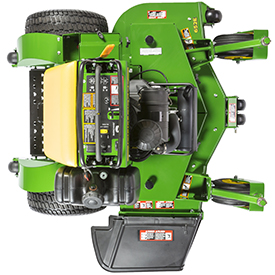 Overhead view of 652E showing compact design
Overhead view of 652E showing compact design
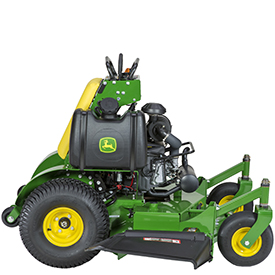 Side view of 652E showing compact design
Side view of 652E showing compact design
From the operator's platform to the mower deck, John Deere QuikTrak™ Mowers have a compact and functional design:
- The compact design allows the QuikTrak to operate in tighter areas that a larger machine cannot. Often, this means the area can be mowed with a QuikTrak so it is not necessary to switch to a walk-behind mower, reducing the time on site.
- With the compact design of QuikTrak Mowers, less space is required on a truck or trailer - which can mean there is room for an extra mower, resulting in less time on property, saving time and money.
 Mowing a tight area with 652R QuikTrak
Mowing a tight area with 652R QuikTrak
 652R QuikTrak
652R QuikTrak
Whether mowing hills or on level terrain, trimming or mowing straight-away, the operator of a John Deere QuikTrak is able to affect the performance of the machine with their body:
- The compact design of the QuikTrak allows the operator to use their body to help control the machine.
- The innovative QuikTrak design puts the operator in line with the rear axle to keep traction when mowing across slopes, providing greater control.
- Faster ground speeds get work done quicker.
- Better traction on slopes gives more control and increased productivity.
- Superior stability gives more control and confidence when mowing hillsides.
- Better visibility allows more-timely operator reaction to the terrain and obstructions.
- Standing area is designed for improved range of motion to allow the operator more room to move and avoid obstacles.
- Minimal operator-station obstruction allows safe and fast exits for clearing mower-path obstacles.
- Operator area is designed for more comfort and less fatigue.
 Inset caster wheels (652E shown)
Inset caster wheels (652E shown)
 Inset caster wheels (652R shown)
Inset caster wheels (652R shown)
John Deere QuikTrak Mowers are designed, tested, and manufactured to provide the best commercial mowing machines available:
- Bull-nosed shape of the front edge of the mower deck allows caster wheels to be set back further, closer to the blades, for more effective ground following capability.
- Compact design takes less space for mowing tighter areas and may allow room for an extra machine when hauling to the worksite.
61-in. (155-cm) fabricated mower deck is stamped from 7-gauge, 0.179-in. (4.6-mm) steel for reliability and performance
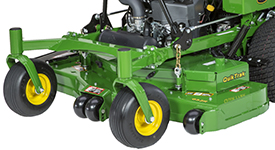 QuikTrak™ mower deck (652R shown)
QuikTrak™ mower deck (652R shown)
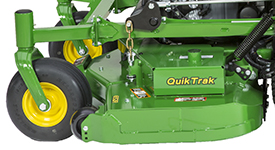 Mower-deck reinforcement (652R shown)
Mower-deck reinforcement (652R shown)
A well-designed mower deck can make the difference between just getting the job done and getting eye-catching results. The 7-gauge, 0.179-in. (4.6-mm) fabricated mower deck delivers a higher quality of cut in more diverse conditions to enhance mowing performance.
Key features of the fabricated mower deck include:
- The mower deck is manufactured from 7-gauge, 0.179-in. (4.6-mm) steel to minimize the number of welds and provide a smooth underside, with fewer sharp corners, for reduced material buildup.
- A compact footprint delivers greater maneuverability when working in tight quarters.
- A deep-deck design delivers excellent airflow so material is processed quickly and efficiently.
- A powerful vacuum effect is created by the deck's unique air-flow design, which pulls more grass upright so that the blades can cut more evenly.
- 48-in. to 61-in. (122-cm to 155-cm) decks come standard with an adjustable striping flap to enhance the after-cut appearance.
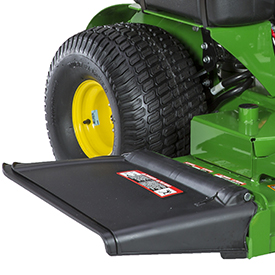 Flexible mower-discharge deflector
Flexible mower-discharge deflector
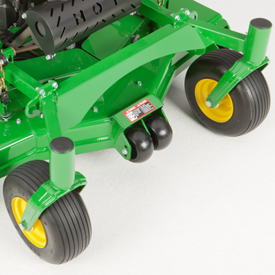 Large, inset caster wheels
Large, inset caster wheels
The wide-discharge opening and raised deflector provide even clipping dispersal for an excellent finished appearance in all conditions.
Caster wheels with flat-free tires contribute to a smooth, even cutting job:
- Large, flat-free caster wheels carry the mower deck smoothly over the lawn.
- Caster wheels are recessed to reduce the vehicle footprint and turning radius.
- With the wheels less exposed, there is less chance they will get snagged by immovable obstacles, thus improving maneuverability and reducing damage.
Anti-scalp rollers are double-captured for durability. They enable the deck to float over the ground and provide a smooth, level cut on even the most challenging terrain.
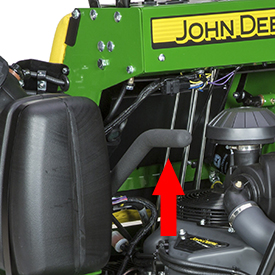 Mower lift lever
Mower lift lever
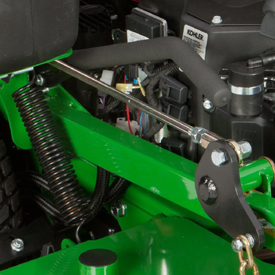 Mower lift spring and lever (minimum cut-height position)
Mower lift spring and lever (minimum cut-height position)
The QuikTrak is equipped with a floating mower deck that offers several advantages over a fixed mower deck:
- The lift lever allows the operator to raise the mower to the full-up position from the operator's station.
- Convenient when transporting from one mowing area to another and when loading/unloading.
- Allows the operator to raise the mower over roots or other obstructions in the lawn on the fly.
- Lift-assist springs reduce the effort required to raise the mower deck.
Cutting and discharging features
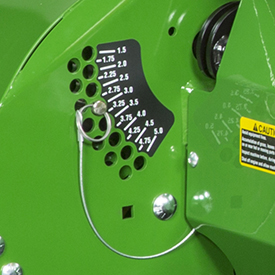 Cutting-height adjustment
Cutting-height adjustment
 Easy-to-remove mower deck shields
Easy-to-remove mower deck shields
Mower cutting height can be set from 1.5 in. (3.8 cm) to 5 in. (12.7 cm) in 0.25-in. (0.64-cm) increments:
- Pull the lift lever back to the fully-raised position.
- Remove the tethered pin and place it at the desired cutting height.
- Lower the lift lever; the lift lever and mower will stop at the desired cutting height.
Mower deck shields are easy to remove, with one knob, for access to the drive belt and other service points.
Optional mulching attachment
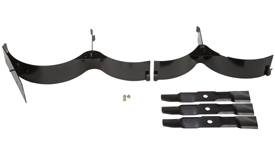 Optional mulching attachment and blades (similar design shown)
Optional mulching attachment and blades (similar design shown)

Optional mulching attachment and special mulching blades are available:
-
This is a high-performance mulching attachment that includes formed steel baffles to control the material for superior performance.
-
The special mulching blades can also be used for side discharging, though overall cutting performance may be slightly less than with the standard blades.
Maximize performance and efficiency with a powerful, electronic fuel injection (EFI) engine
 Engine equipped with electronic fuel injection
Engine equipped with electronic fuel injection
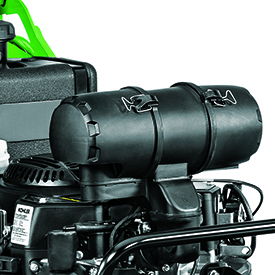 Heavy-duty dual stage air cleaner
Heavy-duty dual stage air cleaner
A commercial-quality, 24.6-hp (18.3-kW) at 3600 rpm, air-cooled engine with EFI powers the QuikTrak™ Mower:
- Overhead valve design
- More horsepower and torque per cubic inch of displacement
- Better fuel efficiency
- EFI
- Closed loop system for improved control of air/fuel mixture
- Immediate starting in hot or cold ambient temperatures or after long periods of seasonal storage
- No choke linkage for the user to operate
- Greater horsepower and torque responsiveness
- Higher reliability with the elimination of vapor locking, misfiring, run-on, and after-bang
- Automatic altitude compensation
- Delivers fuel precisely
- Reduces the potential for plug fouling
- Standard dual-element, canister-type, dry replaceable, heavy-duty air cleaner with secondary safety element
-
V-twin design
-
Fast starts
-
Smooth operation
-
- Vertical shaft for efficient transfer of power to the transmission
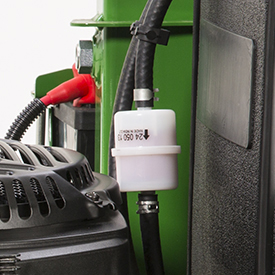 Large, replaceable fuel filter
Large, replaceable fuel filter
 Engine oil cooler
Engine oil cooler
- Fuel pump for consistent and reliable fuel supply to the carburetor
Full-pressure lubrication with full-flow filter
- Reduces engine wear by ensuring proper lubrication, even when operating on hillsides or uneven terrain
-
Filtered oil reduces risk of contamination for increased engine life for increased engine life
-
Oil cooler helps keep engine at optimum temperature
- Air-cooled engine design for minimum maintenance and maximum reliability
- Standard cleanout ports for easy access to remove debris collecting in cooling fins
- Aluminum cylinder block
- Effectively dissipates heat
- Lightweight and strong construction
- Extends engine life due to elimination of debilitating engine temperatures
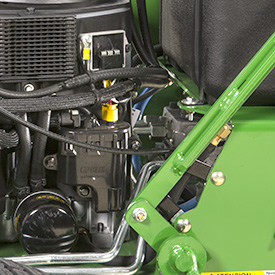 Easy-to-access engine oil filter and drain
Easy-to-access engine oil filter and drain
Engine is equipped with a replaceable oil filter for longer engine life.
Engine oil filter and oil drain are located close together for easy and convenient service.
Hydrostatic drive system is reliable and easy to use
 652R QuikTrak™ Mower mowing
652R QuikTrak™ Mower mowing
 Hydrostatic pumps
Hydrostatic pumps
QuikTrak Mowers use a heavy-duty hydrostatic pump and wheel-motor drive system that gives reliable and consistent performance and long life:
- Heavy-duty components stand up to the rigors of commercial use.
- Individual pump and wheel motor design allows placement of these heavy components low in the vehicle for a low center of gravity and excellent hillside stability.
Two Hydro-Gear™, 0.73 cu in. (12-cc), axial piston, variable-displacement pumps provide hydraulic power to the wheel motors:
- Rugged construction is ideal for high-performance commercial use.
- Piston design gives efficient and consistent performance.
- A replaceable hydraulic filter helps ensure long life of the pumps and wheel motors.
Two individual, 15-cu in. (245.8-cc), piston wheel motors power the QuikTrak drive wheels. Their heavy-duty construction and super-efficient axial-piston design provides superior performance and seamless power to the wheels:
- Integrated high-pressure shaft seal gives greater reliability.
- Large bearings are designed with the capacity to carry heavier loads and give long life.
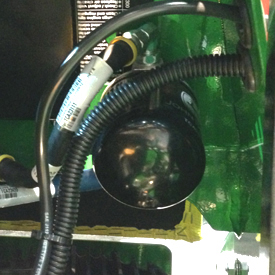 Transmission oil filter
Transmission oil filter
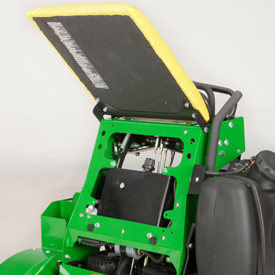 Transmission fluid oil reservoir
Transmission fluid oil reservoir
A spin-on type replaceable hydraulic oil filter is conveniently located:
- Extends life of transmission components by keeping oil clean
- Easy-to-reach for easy and fast service
A hydraulic fluid oil reservoir is located behind the leaning pad:
- Located in a cleaner environment
- Easy to access for inspection and service
- Sight glass built into the tank reduces risk of contamination when checking fluid level.
 Transmission bypass valve
Transmission bypass valve
Transmission bypass valves are provided on each hydrostatic pump to permit moving the QuikTrak without the engine running.
Hydro-Gear is a trademark of Hydro-Gear Limited Partnership AF Holding Company.
Controls are easy to locate and use for operator comfort and productivity
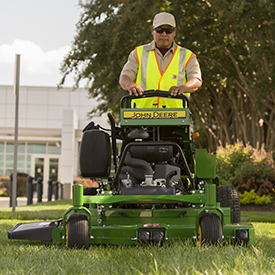 QuikTrak™ Mower mowing (652R shown)
QuikTrak™ Mower mowing (652R shown)
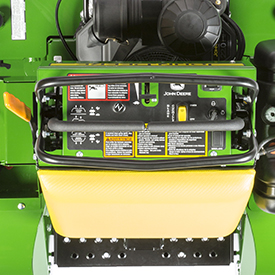 Control console (652E shown)
Control console (652E shown)
Controls are color coded and logically placed to make them easy for the operator to find and use:
- Ground speed and direction are easily controlled by moving the two hand-lever hydrostatic drive controls forward or reverse.
- Speeds are infinitely variable up to 9.5 mph (15.3 km/h) forward and 5.5 mph (8.9 km/h) reverse.
- A positive neutral-lock position for the levers provides added safety.
- Two stationary reference bars are provided for operator convenience and security.
- Front reference bar is included to control speed and reduce fatigue from control lever operation.
- Rear reference bar is included to make reverse operation easy while maintaining operator confidence.
- Control levers return to neutral automatically for safety and convenience.
Separate choke is easy to locate and use.
- Less adjustment is needed with the separate choke.
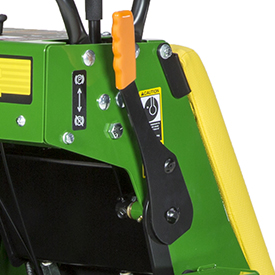 Brake lever (engaged position)
Brake lever (engaged position)
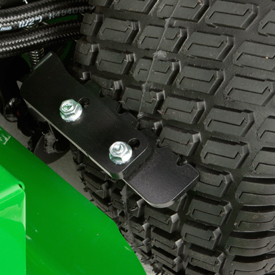 Brake bar
Brake bar
A tire brake is provided to give stability for parking the vehicle on hillsides and for transport; it should be engaged whenever the machine is not being used:
- Brake must be engaged to start the machine, for added safety.
- The tire brake is easily adjusted, if necessary, to maintain effective operation.
Mower deck height-of-cut adjustment (648R, 652R, 661R)
 Mower deck lift handle (648R, 652R, 661R)
Mower deck lift handle (648R, 652R, 661R)
 Mower deck height-of-cut adjustment (648R, 652R, 661R)
Mower deck height-of-cut adjustment (648R, 652R, 661R)
On the 648R, 652R, 652R EFI, 661R, and 661R EFI QuikTrak Mowers, an easy-to-use cutting height adjustment system allows the operator to adjust the mower deck cutting height with no tools and minimal effort:
- Pull the lift lever back to the fully-raised position.
- Remove the tethered pin and place it at the desired cutting height.
- Lower the lift lever; the lift lever and mower will stop at the desired cutting height.
NOTE: Additional information on mower cutting height adjustment can be found in the mower deck section.
Safety features are built-in to protect the operator and bystanders
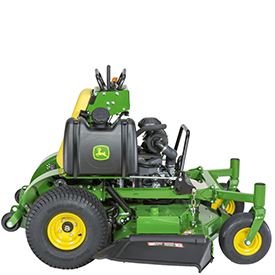 652R QuikTrak™ Mower
652R QuikTrak™ Mower
 Mower discharge deflector
Mower discharge deflector
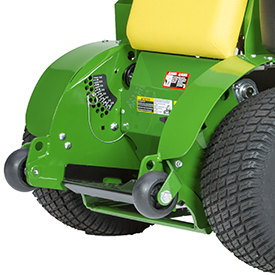 Curb wheels
Curb wheels

Key safety features of QuikTrak Mowers include:
- Start circuit requirements
- Park brake engaged
- Power take-off (PTO) disengaged
- Control levers in neutral
- Ignition key used to start the engine
- A high-quality polyethylene mower-discharge deflector
- Deflects if it strikes a solid obstruction, causing less damage
- Returns to its original shape and function
- Operator station designed to allow fast exit
- Two large curb wheels
- Easy to remove and replace shields
- Stationary handles on either side of the traction controls for operator security
- Control levers return to neutral when released
Mower deck safety certification
QuikTrak mower decks are evaluated by the manufacturer (John Deere Turf Care) and conform to American National Standards Institute (ANSI) B71.4 2004 safety certification specifications for commercial turf care equipment.
Maintenance is simple and easy to reduce time and cost
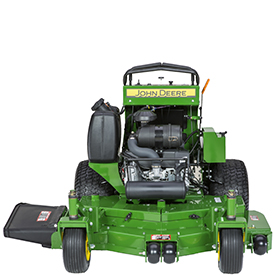 652E QuikTrak™ Mower
652E QuikTrak™ Mower
 Open engine compartment
Open engine compartment
All service components are easy to access:
- Servicing is simplified because of the open engine compartment.
- All service and maintenance points are within easy reach.
 Heavy-duty canister-type air cleaner
Heavy-duty canister-type air cleaner
 Engine oil fill/check tube and oil filter
Engine oil fill/check tube and oil filter
Canister-type heavy-duty air cleaner is easy to reach and easy to service:
- Air cleaner has two filter elements; a large outer filter and a smaller inner safety filter.
- Both filters are easy to access and easy to change.
Engine oil service points are grouped together in easy-to-reach locations:
- Reduces the time required to check and/or change the oil and filter.
 Leaning pad raised for service access
Leaning pad raised for service access
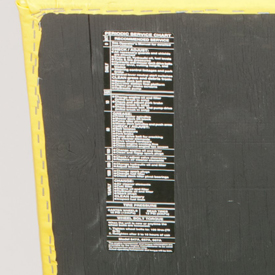 Periodic service chart
Periodic service chart
Simply raising the leaning pad exposes the hydrostatic oil reservoir, control linkage and other service areas.
A periodic service chart is provided for convenience in keeping up on required service.
 Easy-to-remove access panel
Easy-to-remove access panel
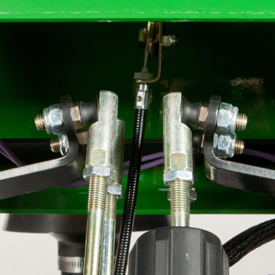 Hydrostatic transmission control linkage
Hydrostatic transmission control linkage
Remove service access shields on the mower deck, battery box, etc. to service the machine:
- Panels are easy to remove and install
Threaded ball and socket rod ends are used throughout the QuikTrak Mowers:
- Provide precise control over a long period of time
- Easily replaced when necessary
 Hydrostatic pump maintenance access
Hydrostatic pump maintenance access
 Transmission bypass valve
Transmission bypass valve
Access to check and service the hydrostatic pumps and motors is readily available at the rear of the machine.
Transmission bypass valves are located on the hydrostatic pumps to enable moving the vehicle without the engine running.
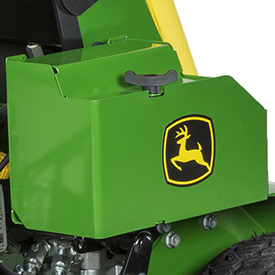 Battery box
Battery box
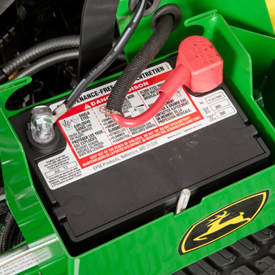 Battery cover removed for service access
Battery cover removed for service access
A secure battery box is provided to protect the battery, for reliable operation:
- Cover is easily removed for servicing the battery.
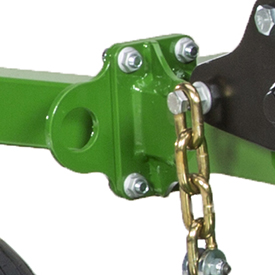 Front tie down
Front tie down
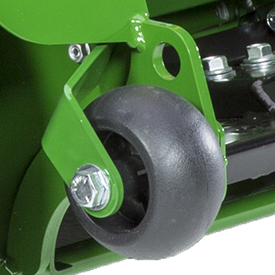 Rear tie down
Rear tie down
Four tie-down locations, two at the front and two at the rear, are provided for safely towing or anchoring the vehicle.
Michelin® X® Tweel® Turf rear tire solution for QuikTrak™ R Series Mowers eliminates downtime
 Tweel rear tire on QuikTrak Mower
Tweel rear tire on QuikTrak Mower
NOTE: 18x8.5N10 Tweel turf tires are available as an ordering option for QuikTrak 648R, 652R, 652R EFI, 661R, and 661R EFI Mowers. Tweels for QuikTrak Mowers are not available as base code equipment.
John Deere leads the commercial zero-turn mower industry with use of the Michelin X Tweel Turf technology for the QuikTrak Mowers.
Michelin is a world leader in tire manufacturing and technology. This airless radial tire solution is an industry first for John Deere, which provides an additional advantage to John Deere operators.
Advantages of the Michelin X Tweel Turf include:
- Mowing performance is improved.
- Unique energy transfer within the poly-resin spokes reduces the bounce associated with pneumatic tires.
- Excellent curb climbing due to the Michelin X Tweel Turf construction and flexibility.
- More consistent cut quality because inconsistent tire pressure is eliminated.
- Uptime is improved.
- The exclusive technology eliminates downtime and associated cost due to flat or damaged tires.
- Punctures and sidewall damage no longer result in downtime.
- Cost of operation is reduced.
- Cost of repairs and maintenance is reduced. One single unit replaces the current tire, wheel, and valve assembly. There is no need for complex tire-mounting equipment.
- No need to spend time checking and optimizing tire pressure.
- The need to purchase and stock plug kits and spare tires is eliminated, particularly for professional landscape contractors and government agencies who normally stock them.
- The tire tread will last up to three times longer than current pneumatic tires because automotive-grade rubber is used for the tread.
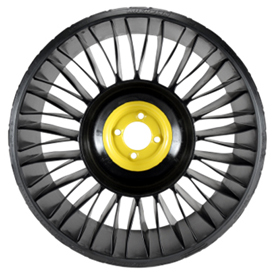 Michelin X Tweel Turf
Michelin X Tweel Turf
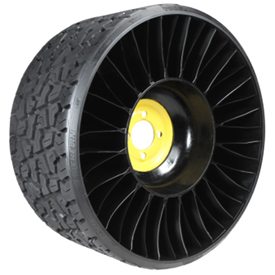 Michelin X Tweel Turf
Michelin X Tweel Turf
Heavy-duty construction provides the ultimate in performance and reliable operation:
- High-strength, poly-resin spokes carry the load.
- Four-hole, heavy-duty steel hub easily bolts onto any R Series QuikTrak Mower.
- Zero degree, high-tensile, proprietary carcass provides great lateral stiffness while resisting damage from impact and penetration.
Michelin, X, and Tweel are trademarks of Michelin North America, Inc.
Features
Compact design for easy hauling and excellent maneuverability
 Overhead view of 652E showing compact design
Overhead view of 652E showing compact design
 Side view of 652E showing compact design
Side view of 652E showing compact design
From the operator's platform to the mower deck, John Deere QuikTrak™ Mowers have a compact and functional design:
- The compact design allows the QuikTrak to operate in tighter areas that a larger machine cannot. Often, this means the area can be mowed with a QuikTrak so it is not necessary to switch to a walk-behind mower, reducing the time on site.
- With the compact design of QuikTrak Mowers, less space is required on a truck or trailer - which can mean there is room for an extra mower, resulting in less time on property, saving time and money.
 Mowing a tight area with 652R QuikTrak
Mowing a tight area with 652R QuikTrak
 652R QuikTrak
652R QuikTrak
Whether mowing hills or on level terrain, trimming or mowing straight-away, the operator of a John Deere QuikTrak is able to affect the performance of the machine with their body:
- The compact design of the QuikTrak allows the operator to use their body to help control the machine.
- The innovative QuikTrak design puts the operator in line with the rear axle to keep traction when mowing across slopes, providing greater control.
- Faster ground speeds get work done quicker.
- Better traction on slopes gives more control and increased productivity.
- Superior stability gives more control and confidence when mowing hillsides.
- Better visibility allows more-timely operator reaction to the terrain and obstructions.
- Standing area is designed for improved range of motion to allow the operator more room to move and avoid obstacles.
- Minimal operator-station obstruction allows safe and fast exits for clearing mower-path obstacles.
- Operator area is designed for more comfort and less fatigue.
 Inset caster wheels (652E shown)
Inset caster wheels (652E shown)
 Inset caster wheels (652R shown)
Inset caster wheels (652R shown)
John Deere QuikTrak Mowers are designed, tested, and manufactured to provide the best commercial mowing machines available:
- Bull-nosed shape of the front edge of the mower deck allows caster wheels to be set back further, closer to the blades, for more effective ground following capability.
- Compact design takes less space for mowing tighter areas and may allow room for an extra machine when hauling to the worksite.
61-in. (155-cm) fabricated mower deck is stamped from 7-gauge, 0.179-in. (4.6-mm) steel for reliability and performance
 QuikTrak™ mower deck (652R shown)
QuikTrak™ mower deck (652R shown)
 Mower-deck reinforcement (652R shown)
Mower-deck reinforcement (652R shown)
A well-designed mower deck can make the difference between just getting the job done and getting eye-catching results. The 7-gauge, 0.179-in. (4.6-mm) fabricated mower deck delivers a higher quality of cut in more diverse conditions to enhance mowing performance.
Key features of the fabricated mower deck include:
- The mower deck is manufactured from 7-gauge, 0.179-in. (4.6-mm) steel to minimize the number of welds and provide a smooth underside, with fewer sharp corners, for reduced material buildup.
- A compact footprint delivers greater maneuverability when working in tight quarters.
- A deep-deck design delivers excellent airflow so material is processed quickly and efficiently.
- A powerful vacuum effect is created by the deck's unique air-flow design, which pulls more grass upright so that the blades can cut more evenly.
- 48-in. to 61-in. (122-cm to 155-cm) decks come standard with an adjustable striping flap to enhance the after-cut appearance.
 Flexible mower-discharge deflector
Flexible mower-discharge deflector
 Large, inset caster wheels
Large, inset caster wheels
The wide-discharge opening and raised deflector provide even clipping dispersal for an excellent finished appearance in all conditions.
Caster wheels with flat-free tires contribute to a smooth, even cutting job:
- Large, flat-free caster wheels carry the mower deck smoothly over the lawn.
- Caster wheels are recessed to reduce the vehicle footprint and turning radius.
- With the wheels less exposed, there is less chance they will get snagged by immovable obstacles, thus improving maneuverability and reducing damage.
Anti-scalp rollers are double-captured for durability. They enable the deck to float over the ground and provide a smooth, level cut on even the most challenging terrain.
 Mower lift lever
Mower lift lever
 Mower lift spring and lever (minimum cut-height position)
Mower lift spring and lever (minimum cut-height position)
The QuikTrak is equipped with a floating mower deck that offers several advantages over a fixed mower deck:
- The lift lever allows the operator to raise the mower to the full-up position from the operator's station.
- Convenient when transporting from one mowing area to another and when loading/unloading.
- Allows the operator to raise the mower over roots or other obstructions in the lawn on the fly.
- Lift-assist springs reduce the effort required to raise the mower deck.
Cutting and discharging features
 Cutting-height adjustment
Cutting-height adjustment
 Easy-to-remove mower deck shields
Easy-to-remove mower deck shields
Mower cutting height can be set from 1.5 in. (3.8 cm) to 5 in. (12.7 cm) in 0.25-in. (0.64-cm) increments:
- Pull the lift lever back to the fully-raised position.
- Remove the tethered pin and place it at the desired cutting height.
- Lower the lift lever; the lift lever and mower will stop at the desired cutting height.
Mower deck shields are easy to remove, with one knob, for access to the drive belt and other service points.
Optional mulching attachment
 Optional mulching attachment and blades (similar design shown)
Optional mulching attachment and blades (similar design shown)

Optional mulching attachment and special mulching blades are available:
-
This is a high-performance mulching attachment that includes formed steel baffles to control the material for superior performance.
-
The special mulching blades can also be used for side discharging, though overall cutting performance may be slightly less than with the standard blades.
Commercial-quality engine is reliable and provides excellent performance and life
 Engine
Engine
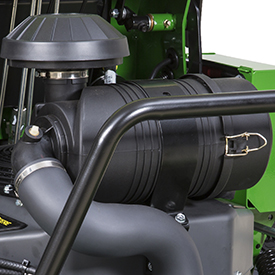 Heavy-duty, dual-stage air cleaner
Heavy-duty, dual-stage air cleaner
A commercial-quality, 23.5-hp (17.5-kW) at 3600 rpm, air-cooled engine powers the QuikTrak™ Mower:
- Overhead valve design
- More horsepower and torque per cubic inch of displacement
- Better fuel efficiency
- Full-pressure lubrication with full-flow filter
-
Reduces engine wear by ensuring proper lubrication, even when operating on hillsides or uneven terrain
-
Filtered oil reduces risk of contamination for increased engine life
-
-
V-twin design
-
Fast starts
-
Smooth operation
-
- Vertical shaft for efficient transfer of power to the transmission
- Standard dual-element, canister-type, dry replaceable, heavy-duty air cleaner with secondary safety element
- Fuel pump for consistent and reliable fuel supply to the carburetor
- 50-state compliant engine, which complies with strict U.S. Environmental Protection Agency and California Air Resources Board emission standards, without loss of horsepower or torque
- Air-cooled engine design for minimum maintenance and maximum reliability
- Standard cleanout ports for easy access to remove debris collecting in cooling fins
- Aluminum cylinder block
- Effectively dissipates heat
- Lightweight and strong construction
- Extends engine life due to elimination of debilitating engine temperatures
 Engine oil-fill tube, filter, and drain
Engine oil-fill tube, filter, and drain

The engine is equipped with a replaceable oil filter for longer engine life.
Engine oil fill/check tube, oil filter, and oil drain are located close together for easy and convenient service.
Field-installed propane conversion kits for Commercial Walk-Behind Mowers, QuikTrak™ Mowers, and Commercial ZTrak™ Mowers
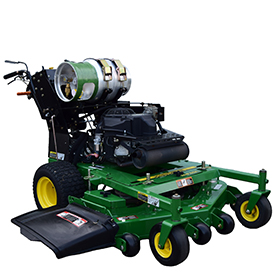 Propane conversion kit on a Walk-Behind Mower
Propane conversion kit on a Walk-Behind Mower
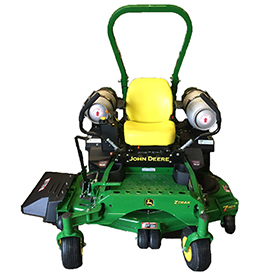 Propane conversion kit on a ZTrak Mower
Propane conversion kit on a ZTrak Mower
John Deere provides application-specific Environmental Protection Agency (EPA) approved field-installed propane conversion kits for specific John Deere Commercial Walk-Behind Mowers, QuikTrak Mowers, and ZTrak Mowers. The conversion kits include all components required to convert the engines to operate on propane fuel. Single-tank or dual-tank brackets (depending on the vehicle) are provided for securely holding the propane tank(s) to the vehicle.
Propane tanks are not included.
An optional altitude kit is required when operating at altitudes above 2000 ft (610 m). The operator’s manual with the propane conversion kit provides further details. Parts must be ordered separately through John Deere Parts.
Propane facts:
- Propane is flammable and commonly used as a fuel.
- The molecular formula of propane is C3H8, and it is in the family of liquefied petroleum gases (LP gases). The other LP gases include butane, propylene, butadiene, butylene, isobutylene, and mixtures thereof.
- Propane is commonly available and has proven to be a dependable, safe, economical, and clean-burning fuel. It can be used as household fuel, industrial fuel, and fuel for internal combustion engines. Propane has been used as a fuel since 1910.
- At atmospheric pressure, propane boils at -44°F (-42.2°C), meaning it typically exists as a vapor. However, when contained under pressure, such as in a propane cylinder, it can exist as a liquid.
- Propane is naturally odorless, but includes an additive odorant, usually mercaptan, which gives it a distinct odor.
- Vapor propane is heavier than air, meaning it will settle in low areas such as along the ground or in drains.
Advantages of John Deere propane conversion kits include:
- Reduced fuel costs, up to 30 percent depending on fuel prices
- Lower emissions
- Reduced fuel-system maintenance
- Maintains John Deere warranty
- EPA and CARB certified
- May qualify for national and state rebate and incentive programs. Please visit www.propane.com/commercial-landscape/programs-and-incentives/ for further information.
Propane tank mounting bracket options:
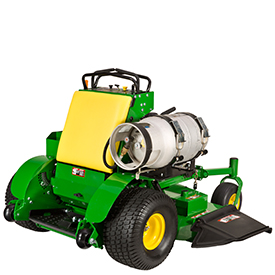 Single propane tank shown on QuikTrak Mower
Single propane tank shown on QuikTrak Mower
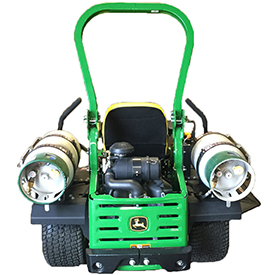 Dual propane tanks shown on ZTrak Mower
Dual propane tanks shown on ZTrak Mower
Optional tank configurations and sizes are available to provide operators the ability to tailor for run time:
- Commercial Walk-Behind Mowers have only a single-tank mounting option.
- The single-tank bracket is designed for one 20-lb (9.1-kg) or 33-lb (15-kg) Worthington tank.
- Tank is not included.
- The single-tank bracket is designed for one 20-lb (9.1-kg) or 33-lb (15-kg) Worthington tank.
- QuikTrak Mowers have single-tank and dual-tank mounting options.
- The single-tank, right-side bracket is designed for one 33-lb (15-kg) Worthington tank.
- Tank is not included.
- The dual-tank brackets are designed for two 20-lb (9.1-kg) Worthington tanks.
- Tanks are not included.
- The single-tank, right-side bracket is designed for one 33-lb (15-kg) Worthington tank.
- ZTrak Mowers have single-tank and dual-tank mounting options.
- The single-tank, left-side bracket is designed for one 33-lb (15-kg) or 43-lb (19.5-kg) Worthington tank.
- Tank is not included.
- The dual-tank brackets are designed for two 33-lb (15-kg) Worthington tanks.
- Tanks are not included.
- ZTrak Mowers with dual-tank configurations are not compatible with any material collection systems.
NOTE: Reference the Propane and Attachment Compatibility Chart to determine tank configurations that are compatible.
Estimated run-time comparison
| Engine displacement | FS603cc | FS726cc | FX726cc | FX852cc |
| Average consumption (lb [kg]/hr) | 3.9 (1.8) | 4.2 (1.9) | 4.2 (1.9) | 5.8 (2.6) |
| Run time (hours) with 20-lb (9.1-kg) tank | 5.1 | 4.8 | 4.8 | 3.4 |
| Run time (hours) with 33.5-lb (15.2-kg) tank | Not available | 8.0 | 8.0 | 5.8 |
| Run time (hours) with 43.5-lb (19.7-kg) tank | Not available | 10.4 | 10.4 | 7.5 |
Field-installed propane conversion kit compatibility:
NOTE: Conversion to propane is not intended for units with engines having more than 250 hours of use.
Commercial Walk-Behind Mowers (model year 2018 and prior)
| WG Series | WH Series | WHP Series | |||||||||
| Model | WG32A | WG36A | WG48A | WH36A | WH48A | WH52A | WH61A | WHP36A | WHP48A | WHP52A | WHP61A |
| Engine model | FS481V | FS481V | FS481V | FS481V | FS600V | FS600V | FS691V | FS481V | FS600V | FS600V | FS691V |
| Engine displacement | 603 cc | 603 cc | 603 cc | 603 cc | 603 cc | 603 cc | 726 cc | 603 cc | 603 cc | 603 cc | 726 cc |
| Propane kit model number | Not available | Not available | Not available | FS603cc | FS603cc | FS603cc | FS726cc | FS603cc | FS603cc | FS603cc | FS726cc |
QuikTrak Mowers
| E Series | M Series | R Series | |||||||
| Model | 652E | 636M | 648M | 652M | 648R | 652R | 652R EFI | 661R | 661R EFI |
| Engine model | FX691V | FS600V | FX691V | FX691V | FX691V | FX730V | ECV740 EFI | FX730V | ECV740 EFI |
| Engine displacement | 726 cc | 603 cc | 726 cc | 726 cc | 726 cc | 726 cc | 747 cc | 726 cc | 747 cc |
| Propane kit model number | FX726cc | Not available | Not available | Not available | FX726cc | FX726cc | Not available | FX726cc | Not available |
Commercial ZTrak Mowers
| E Series | M Series | R Series | |||||||||
| Model | Z915E | Z920M | Z930M | Z945M EFI | Z950M | Z955M EFI | Z960M | Z930R | Z950R | Z955R EFI | Z970R |
| Engine model | CV742 | FX730V | FX801V | ECV850 EFI | FX850V | ECV860J EFI | FX921V | FX801V | FX850V | ECV860J EFI | FX1000V |
| Engine displacement | 747 cc | 726 cc | 852 cc | 824 cc | 852 cc | 824 cc | 999 cc | 852 cc | 852 cc | 824 cc | 999 cc |
| Propane kit model number | Not available | FX726cc* | FX852cc* | Not available | FX852cc* | Not available | Not available | FX852cc* | FX852cc* | Not available | Not available |
Worthington tanks are manufactured by Worthington Industries, Inc.
Hydrostatic drive system is reliable and easy to use
 652R QuikTrak™ Mower mowing
652R QuikTrak™ Mower mowing
 Hydrostatic pumps
Hydrostatic pumps
QuikTrak Mowers use a heavy-duty hydrostatic pump and wheel-motor drive system that gives reliable and consistent performance and long life:
- Heavy-duty components stand up to the rigors of commercial use.
- Individual pump and wheel motor design allows placement of these heavy components low in the vehicle for a low center of gravity and excellent hillside stability.
Two Hydro-Gear™, 0.73 cu in. (12-cc), axial piston, variable-displacement pumps provide hydraulic power to the wheel motors:
- Rugged construction is ideal for high-performance commercial use.
- Piston design gives efficient and consistent performance.
- A replaceable hydraulic filter helps ensure long life of the pumps and wheel motors.
Two individual, 15-cu in. (245.8-cc), piston wheel motors power the QuikTrak drive wheels. Their heavy-duty construction and super-efficient axial-piston design provides superior performance and seamless power to the wheels:
- Integrated high-pressure shaft seal gives greater reliability.
- Large bearings are designed with the capacity to carry heavier loads and give long life.
 Transmission oil filter
Transmission oil filter
 Transmission fluid oil reservoir
Transmission fluid oil reservoir
A spin-on type replaceable hydraulic oil filter is conveniently located:
- Extends life of transmission components by keeping oil clean
- Easy-to-reach for easy and fast service
A hydraulic fluid oil reservoir is located behind the leaning pad:
- Located in a cleaner environment
- Easy to access for inspection and service
- Sight glass built into the tank reduces risk of contamination when checking fluid level.
 Transmission bypass valve
Transmission bypass valve
Transmission bypass valves are provided on each hydrostatic pump to permit moving the QuikTrak without the engine running.
Hydro-Gear is a trademark of Hydro-Gear Limited Partnership AF Holding Company.
Controls are easy to locate and use for operator comfort and productivity
 QuikTrak™ Mower mowing (652R shown)
QuikTrak™ Mower mowing (652R shown)
 Control console (652E shown)
Control console (652E shown)
Controls are color coded and logically placed to make them easy for the operator to find and use:
- Ground speed and direction are easily controlled by moving the two hand-lever hydrostatic drive controls forward or reverse.
- Speeds are infinitely variable up to 9.5 mph (15.3 km/h) forward and 5.5 mph (8.9 km/h) reverse.
- A positive neutral-lock position for the levers provides added safety.
- Two stationary reference bars are provided for operator convenience and security.
- Front reference bar is included to control speed and reduce fatigue from control lever operation.
- Rear reference bar is included to make reverse operation easy while maintaining operator confidence.
- Control levers return to neutral automatically for safety and convenience.
Separate choke is easy to locate and use.
- Less adjustment is needed with the separate choke.
 Brake lever (engaged position)
Brake lever (engaged position)
 Brake bar
Brake bar
A tire brake is provided to give stability for parking the vehicle on hillsides and for transport; it should be engaged whenever the machine is not being used:
- Brake must be engaged to start the machine, for added safety.
- The tire brake is easily adjusted, if necessary, to maintain effective operation.
Mower deck height-of-cut adjustment (648R, 652R, 661R)
 Mower deck lift handle (648R, 652R, 661R)
Mower deck lift handle (648R, 652R, 661R)
 Mower deck height-of-cut adjustment (648R, 652R, 661R)
Mower deck height-of-cut adjustment (648R, 652R, 661R)
On the 648R, 652R, 652R EFI, 661R, and 661R EFI QuikTrak Mowers, an easy-to-use cutting height adjustment system allows the operator to adjust the mower deck cutting height with no tools and minimal effort:
- Pull the lift lever back to the fully-raised position.
- Remove the tethered pin and place it at the desired cutting height.
- Lower the lift lever; the lift lever and mower will stop at the desired cutting height.
NOTE: Additional information on mower cutting height adjustment can be found in the mower deck section.
Safety features are built-in to protect the operator and bystanders
 652R QuikTrak™ Mower
652R QuikTrak™ Mower
 Mower discharge deflector
Mower discharge deflector
 Curb wheels
Curb wheels

Key safety features of QuikTrak Mowers include:
- Start circuit requirements
- Park brake engaged
- Power take-off (PTO) disengaged
- Control levers in neutral
- Ignition key used to start the engine
- A high-quality polyethylene mower-discharge deflector
- Deflects if it strikes a solid obstruction, causing less damage
- Returns to its original shape and function
- Operator station designed to allow fast exit
- Two large curb wheels
- Easy to remove and replace shields
- Stationary handles on either side of the traction controls for operator security
- Control levers return to neutral when released
Mower deck safety certification
QuikTrak mower decks are evaluated by the manufacturer (John Deere Turf Care) and conform to American National Standards Institute (ANSI) B71.4 2004 safety certification specifications for commercial turf care equipment.
Maintenance is simple and easy to reduce time and cost
 652E QuikTrak™ Mower
652E QuikTrak™ Mower
 Open engine compartment
Open engine compartment
All service components are easy to access:
- Servicing is simplified because of the open engine compartment.
- All service and maintenance points are within easy reach.
 Heavy-duty canister-type air cleaner
Heavy-duty canister-type air cleaner
 Engine oil fill/check tube and oil filter
Engine oil fill/check tube and oil filter
Canister-type heavy-duty air cleaner is easy to reach and easy to service:
- Air cleaner has two filter elements; a large outer filter and a smaller inner safety filter.
- Both filters are easy to access and easy to change.
Engine oil service points are grouped together in easy-to-reach locations:
- Reduces the time required to check and/or change the oil and filter.
 Leaning pad raised for service access
Leaning pad raised for service access
 Periodic service chart
Periodic service chart
Simply raising the leaning pad exposes the hydrostatic oil reservoir, control linkage and other service areas.
A periodic service chart is provided for convenience in keeping up on required service.
 Easy-to-remove access panel
Easy-to-remove access panel
 Hydrostatic transmission control linkage
Hydrostatic transmission control linkage
Remove service access shields on the mower deck, battery box, etc. to service the machine:
- Panels are easy to remove and install
Threaded ball and socket rod ends are used throughout the QuikTrak Mowers:
- Provide precise control over a long period of time
- Easily replaced when necessary
 Hydrostatic pump maintenance access
Hydrostatic pump maintenance access
 Transmission bypass valve
Transmission bypass valve
Access to check and service the hydrostatic pumps and motors is readily available at the rear of the machine.
Transmission bypass valves are located on the hydrostatic pumps to enable moving the vehicle without the engine running.
 Battery box
Battery box
 Battery cover removed for service access
Battery cover removed for service access
A secure battery box is provided to protect the battery, for reliable operation:
- Cover is easily removed for servicing the battery.
 Front tie down
Front tie down
 Rear tie down
Rear tie down
Four tie-down locations, two at the front and two at the rear, are provided for safely towing or anchoring the vehicle.
Michelin® X® Tweel® Turf rear tire solution for QuikTrak™ R Series Mowers eliminates downtime
 Tweel rear tire on QuikTrak Mower
Tweel rear tire on QuikTrak Mower
NOTE: 18x8.5N10 Tweel turf tires are available as an ordering option for QuikTrak 648R, 652R, 652R EFI, 661R, and 661R EFI Mowers. Tweels for QuikTrak Mowers are not available as base code equipment.
John Deere leads the commercial zero-turn mower industry with use of the Michelin X Tweel Turf technology for the QuikTrak Mowers.
Michelin is a world leader in tire manufacturing and technology. This airless radial tire solution is an industry first for John Deere, which provides an additional advantage to John Deere operators.
Advantages of the Michelin X Tweel Turf include:
- Mowing performance is improved.
- Unique energy transfer within the poly-resin spokes reduces the bounce associated with pneumatic tires.
- Excellent curb climbing due to the Michelin X Tweel Turf construction and flexibility.
- More consistent cut quality because inconsistent tire pressure is eliminated.
- Uptime is improved.
- The exclusive technology eliminates downtime and associated cost due to flat or damaged tires.
- Punctures and sidewall damage no longer result in downtime.
- Cost of operation is reduced.
- Cost of repairs and maintenance is reduced. One single unit replaces the current tire, wheel, and valve assembly. There is no need for complex tire-mounting equipment.
- No need to spend time checking and optimizing tire pressure.
- The need to purchase and stock plug kits and spare tires is eliminated, particularly for professional landscape contractors and government agencies who normally stock them.
- The tire tread will last up to three times longer than current pneumatic tires because automotive-grade rubber is used for the tread.
 Michelin X Tweel Turf
Michelin X Tweel Turf
 Michelin X Tweel Turf
Michelin X Tweel Turf
Heavy-duty construction provides the ultimate in performance and reliable operation:
- High-strength, poly-resin spokes carry the load.
- Four-hole, heavy-duty steel hub easily bolts onto any R Series QuikTrak Mower.
- Zero degree, high-tensile, proprietary carcass provides great lateral stiffness while resisting damage from impact and penetration.
Michelin, X, and Tweel are trademarks of Michelin North America, Inc.
Features
Compact design for easy hauling and excellent maneuverability
 Overhead view of 652E showing compact design
Overhead view of 652E showing compact design
 Side view of 652E showing compact design
Side view of 652E showing compact design
From the operator's platform to the mower deck, John Deere QuikTrak™ Mowers have a compact and functional design:
- The compact design allows the QuikTrak to operate in tighter areas that a larger machine cannot. Often, this means the area can be mowed with a QuikTrak so it is not necessary to switch to a walk-behind mower, reducing the time on site.
- With the compact design of QuikTrak Mowers, less space is required on a truck or trailer - which can mean there is room for an extra mower, resulting in less time on property, saving time and money.
 Mowing a tight area with 652R QuikTrak
Mowing a tight area with 652R QuikTrak
 652R QuikTrak
652R QuikTrak
Whether mowing hills or on level terrain, trimming or mowing straight-away, the operator of a John Deere QuikTrak is able to affect the performance of the machine with their body:
- The compact design of the QuikTrak allows the operator to use their body to help control the machine.
- The innovative QuikTrak design puts the operator in line with the rear axle to keep traction when mowing across slopes, providing greater control.
- Faster ground speeds get work done quicker.
- Better traction on slopes gives more control and increased productivity.
- Superior stability gives more control and confidence when mowing hillsides.
- Better visibility allows more-timely operator reaction to the terrain and obstructions.
- Standing area is designed for improved range of motion to allow the operator more room to move and avoid obstacles.
- Minimal operator-station obstruction allows safe and fast exits for clearing mower-path obstacles.
- Operator area is designed for more comfort and less fatigue.
 Inset caster wheels (652E shown)
Inset caster wheels (652E shown)
 Inset caster wheels (652R shown)
Inset caster wheels (652R shown)
John Deere QuikTrak Mowers are designed, tested, and manufactured to provide the best commercial mowing machines available:
- Bull-nosed shape of the front edge of the mower deck allows caster wheels to be set back further, closer to the blades, for more effective ground following capability.
- Compact design takes less space for mowing tighter areas and may allow room for an extra machine when hauling to the worksite.
52-in. (132-cm) fabricated mower deck is made from 7-gauge, 0.179-in. (4.6-mm) steel for reliability and performance
 652R QuikTrak™ mower deck
652R QuikTrak™ mower deck
 652R QuikTrak mower deck reinforcement
652R QuikTrak mower deck reinforcement
A well-designed mower deck can make the difference between just getting the job done and getting eye-catching results. The 7-gauge, 0.179-in. (4.6-mm) fabricated mower deck delivers an even higher quality of cut in even more diverse conditions to enhance mowing performance.
Key features of the fabricated mower deck include:
- The mower deck is manufactured from 7-gauge, 0.179-in. (4.6-mm) steel to minimize the number of welds and provide a smooth underside, with fewer sharp corners, for reduced material buildup.
- A compact footprint delivers greater maneuverability when working in tight quarters.
- A deep-deck design delivers excellent airflow so material is processed quickly and efficiently.
- A powerful vacuum effect is created by the deck's unique air-flow design, which pulls more grass upright so that the blades can cut more evenly.
- 48-in. to 61-in. (122-cm to 155-cm) decks come standard with an adjustable striping flap to enhance the after-cut appearance.
 Flexible mower-discharge deflector
Flexible mower-discharge deflector
 Large, inset caster wheels
Large, inset caster wheels
The wide-discharge opening and raised deflector provide even clipping dispersal for an excellent finished appearance in all conditions.
Caster wheels with flat-free tires contribute to a smooth, even cutting job:
- Large, flat-free caster wheels carry the mower deck smoothly over the lawn.
- Caster wheels are recessed to reduce the vehicle footprint and turning radius.
- With the wheels less exposed, there is less chance they will get snagged by immovable obstacles, thus improving maneuverability and reducing damage.
Anti-scalp rollers are double-captured for durability. They enable the deck to float over the ground and provide a smooth, level cut on even the most challenging terrain.
 Mower lift lever
Mower lift lever
 Mower lift spring and lever (minimum cut-height position)
Mower lift spring and lever (minimum cut-height position)
The QuikTrak is equipped with a floating mower deck that offers several advantages over a fixed mower deck:
- The lift lever allows the operator to raise the mower to the fully-up position from the operator's station.
- Convenient when transporting from one mowing area to another and when loading/unloading.
- Allows the operator to raise the mower over roots or other obstructions in the lawn on the fly.
- Lift-assist springs reduce the effort required to raise the mower deck.
 Cutting-height adjustment
Cutting-height adjustment
 Easy-to-remove mower deck shields
Easy-to-remove mower deck shields
Mower cutting height can be set from 1.5 in. (3.8 cm) to 5 in. (12.7 cm) in 0.25-in. (0.64-cm) increments:
- Pull the lift lever back to the full-raised position.
- Remove the tethered pin and place it at the desired cutting height.
- Lower the lift lever; the lift lever and mower will stop at the desired cutting height.
Mower deck shields are easy to remove for access to the drive belt and other service points.
Optional mulching attachment
 Optional mulching attachment and blades (similar design shown)
Optional mulching attachment and blades (similar design shown)

Optional mulching attachment and special mulching blades are available:
-
This is a high-performance mulching attachment that includes formed steel baffles to control the material for superior performance.
-
The special mulching blades can also be used for side discharging, though overall cutting performance may be slightly less than with the standard blades.
Maximize performance and efficiency with a powerful, electronic fuel injection (EFI) engine
 Engine equipped with electronic fuel injection
Engine equipped with electronic fuel injection
 Heavy-duty dual stage air cleaner
Heavy-duty dual stage air cleaner
A commercial-quality, 24.6-hp (18.3-kW) at 3600 rpm, air-cooled engine with EFI powers the QuikTrak™ Mower:
- Overhead valve design
- More horsepower and torque per cubic inch of displacement
- Better fuel efficiency
- EFI
- Closed loop system for improved control of air/fuel mixture
- Immediate starting in hot or cold ambient temperatures or after long periods of seasonal storage
- No choke linkage for the user to operate
- Greater horsepower and torque responsiveness
- Higher reliability with the elimination of vapor locking, misfiring, run-on, and after-bang
- Automatic altitude compensation
- Delivers fuel precisely
- Reduces the potential for plug fouling
- Standard dual-element, canister-type, dry replaceable, heavy-duty air cleaner with secondary safety element
-
V-twin design
-
Fast starts
-
Smooth operation
-
- Vertical shaft for efficient transfer of power to the transmission
 Large, replaceable fuel filter
Large, replaceable fuel filter
 Engine oil cooler
Engine oil cooler
- Fuel pump for consistent and reliable fuel supply to the carburetor
Full-pressure lubrication with full-flow filter
- Reduces engine wear by ensuring proper lubrication, even when operating on hillsides or uneven terrain
-
Filtered oil reduces risk of contamination for increased engine life for increased engine life
-
Oil cooler helps keep engine at optimum temperature
- Air-cooled engine design for minimum maintenance and maximum reliability
- Standard cleanout ports for easy access to remove debris collecting in cooling fins
- Aluminum cylinder block
- Effectively dissipates heat
- Lightweight and strong construction
- Extends engine life due to elimination of debilitating engine temperatures
 Easy-to-access engine oil filter and drain
Easy-to-access engine oil filter and drain
Engine is equipped with a replaceable oil filter for longer engine life.
Engine oil filter and oil drain are located close together for easy and convenient service.
Hydrostatic drive system is reliable and easy to use
 652R QuikTrak™ Mower mowing
652R QuikTrak™ Mower mowing
 Hydrostatic pumps
Hydrostatic pumps
QuikTrak Mowers use a heavy-duty hydrostatic pump and wheel-motor drive system that gives reliable and consistent performance and long life:
- Heavy-duty components stand up to the rigors of commercial use.
- Individual pump and wheel motor design allows placement of these heavy components low in the vehicle for a low center of gravity and excellent hillside stability.
Two Hydro-Gear™, 0.73 cu in. (12-cc), axial piston, variable-displacement pumps provide hydraulic power to the wheel motors:
- Rugged construction is ideal for high-performance commercial use.
- Piston design gives efficient and consistent performance.
- A replaceable hydraulic filter helps ensure long life of the pumps and wheel motors.
Two individual, 15-cu in. (245.8-cc), piston wheel motors power the QuikTrak drive wheels. Their heavy-duty construction and super-efficient axial-piston design provides superior performance and seamless power to the wheels:
- Integrated high-pressure shaft seal gives greater reliability.
- Large bearings are designed with the capacity to carry heavier loads and give long life.
 Transmission oil filter
Transmission oil filter
 Transmission fluid oil reservoir
Transmission fluid oil reservoir
A spin-on type replaceable hydraulic oil filter is conveniently located:
- Extends life of transmission components by keeping oil clean
- Easy-to-reach for easy and fast service
A hydraulic fluid oil reservoir is located behind the leaning pad:
- Located in a cleaner environment
- Easy to access for inspection and service
- Sight glass built into the tank reduces risk of contamination when checking fluid level.
 Transmission bypass valve
Transmission bypass valve
Transmission bypass valves are provided on each hydrostatic pump to permit moving the QuikTrak without the engine running.
Hydro-Gear is a trademark of Hydro-Gear Limited Partnership AF Holding Company.
Controls are easy to locate and use for operator comfort and productivity
 QuikTrak™ Mower mowing (652R shown)
QuikTrak™ Mower mowing (652R shown)
 Control console (652E shown)
Control console (652E shown)
Controls are color coded and logically placed to make them easy for the operator to find and use:
- Ground speed and direction are easily controlled by moving the two hand-lever hydrostatic drive controls forward or reverse.
- Speeds are infinitely variable up to 9.5 mph (15.3 km/h) forward and 5.5 mph (8.9 km/h) reverse.
- A positive neutral-lock position for the levers provides added safety.
- Two stationary reference bars are provided for operator convenience and security.
- Front reference bar is included to control speed and reduce fatigue from control lever operation.
- Rear reference bar is included to make reverse operation easy while maintaining operator confidence.
- Control levers return to neutral automatically for safety and convenience.
Separate choke is easy to locate and use.
- Less adjustment is needed with the separate choke.
 Brake lever (engaged position)
Brake lever (engaged position)
 Brake bar
Brake bar
A tire brake is provided to give stability for parking the vehicle on hillsides and for transport; it should be engaged whenever the machine is not being used:
- Brake must be engaged to start the machine, for added safety.
- The tire brake is easily adjusted, if necessary, to maintain effective operation.
Mower deck height-of-cut adjustment (648R, 652R, 661R)
 Mower deck lift handle (648R, 652R, 661R)
Mower deck lift handle (648R, 652R, 661R)
 Mower deck height-of-cut adjustment (648R, 652R, 661R)
Mower deck height-of-cut adjustment (648R, 652R, 661R)
On the 648R, 652R, 652R EFI, 661R, and 661R EFI QuikTrak Mowers, an easy-to-use cutting height adjustment system allows the operator to adjust the mower deck cutting height with no tools and minimal effort:
- Pull the lift lever back to the fully-raised position.
- Remove the tethered pin and place it at the desired cutting height.
- Lower the lift lever; the lift lever and mower will stop at the desired cutting height.
NOTE: Additional information on mower cutting height adjustment can be found in the mower deck section.
Safety features are built-in to protect the operator and bystanders
 652R QuikTrak™ Mower
652R QuikTrak™ Mower
 Mower discharge deflector
Mower discharge deflector
 Curb wheels
Curb wheels

Key safety features of QuikTrak Mowers include:
- Start circuit requirements
- Park brake engaged
- Power take-off (PTO) disengaged
- Control levers in neutral
- Ignition key used to start the engine
- A high-quality polyethylene mower-discharge deflector
- Deflects if it strikes a solid obstruction, causing less damage
- Returns to its original shape and function
- Operator station designed to allow fast exit
- Two large curb wheels
- Easy to remove and replace shields
- Stationary handles on either side of the traction controls for operator security
- Control levers return to neutral when released
Mower deck safety certification
QuikTrak mower decks are evaluated by the manufacturer (John Deere Turf Care) and conform to American National Standards Institute (ANSI) B71.4 2004 safety certification specifications for commercial turf care equipment.
Maintenance is simple and easy to reduce time and cost
 652E QuikTrak™ Mower
652E QuikTrak™ Mower
 Open engine compartment
Open engine compartment
All service components are easy to access:
- Servicing is simplified because of the open engine compartment.
- All service and maintenance points are within easy reach.
 Heavy-duty canister-type air cleaner
Heavy-duty canister-type air cleaner
 Engine oil fill/check tube and oil filter
Engine oil fill/check tube and oil filter
Canister-type heavy-duty air cleaner is easy to reach and easy to service:
- Air cleaner has two filter elements; a large outer filter and a smaller inner safety filter.
- Both filters are easy to access and easy to change.
Engine oil service points are grouped together in easy-to-reach locations:
- Reduces the time required to check and/or change the oil and filter.
 Leaning pad raised for service access
Leaning pad raised for service access
 Periodic service chart
Periodic service chart
Simply raising the leaning pad exposes the hydrostatic oil reservoir, control linkage and other service areas.
A periodic service chart is provided for convenience in keeping up on required service.
 Easy-to-remove access panel
Easy-to-remove access panel
 Hydrostatic transmission control linkage
Hydrostatic transmission control linkage
Remove service access shields on the mower deck, battery box, etc. to service the machine:
- Panels are easy to remove and install
Threaded ball and socket rod ends are used throughout the QuikTrak Mowers:
- Provide precise control over a long period of time
- Easily replaced when necessary
 Hydrostatic pump maintenance access
Hydrostatic pump maintenance access
 Transmission bypass valve
Transmission bypass valve
Access to check and service the hydrostatic pumps and motors is readily available at the rear of the machine.
Transmission bypass valves are located on the hydrostatic pumps to enable moving the vehicle without the engine running.
 Battery box
Battery box
 Battery cover removed for service access
Battery cover removed for service access
A secure battery box is provided to protect the battery, for reliable operation:
- Cover is easily removed for servicing the battery.
 Front tie down
Front tie down
 Rear tie down
Rear tie down
Four tie-down locations, two at the front and two at the rear, are provided for safely towing or anchoring the vehicle.
Michelin® X® Tweel® Turf rear tire solution for QuikTrak™ R Series Mowers eliminates downtime
 Tweel rear tire on QuikTrak Mower
Tweel rear tire on QuikTrak Mower
NOTE: 18x8.5N10 Tweel turf tires are available as an ordering option for QuikTrak 648R, 652R, 652R EFI, 661R, and 661R EFI Mowers. Tweels for QuikTrak Mowers are not available as base code equipment.
John Deere leads the commercial zero-turn mower industry with use of the Michelin X Tweel Turf technology for the QuikTrak Mowers.
Michelin is a world leader in tire manufacturing and technology. This airless radial tire solution is an industry first for John Deere, which provides an additional advantage to John Deere operators.
Advantages of the Michelin X Tweel Turf include:
- Mowing performance is improved.
- Unique energy transfer within the poly-resin spokes reduces the bounce associated with pneumatic tires.
- Excellent curb climbing due to the Michelin X Tweel Turf construction and flexibility.
- More consistent cut quality because inconsistent tire pressure is eliminated.
- Uptime is improved.
- The exclusive technology eliminates downtime and associated cost due to flat or damaged tires.
- Punctures and sidewall damage no longer result in downtime.
- Cost of operation is reduced.
- Cost of repairs and maintenance is reduced. One single unit replaces the current tire, wheel, and valve assembly. There is no need for complex tire-mounting equipment.
- No need to spend time checking and optimizing tire pressure.
- The need to purchase and stock plug kits and spare tires is eliminated, particularly for professional landscape contractors and government agencies who normally stock them.
- The tire tread will last up to three times longer than current pneumatic tires because automotive-grade rubber is used for the tread.
 Michelin X Tweel Turf
Michelin X Tweel Turf
 Michelin X Tweel Turf
Michelin X Tweel Turf
Heavy-duty construction provides the ultimate in performance and reliable operation:
- High-strength, poly-resin spokes carry the load.
- Four-hole, heavy-duty steel hub easily bolts onto any R Series QuikTrak Mower.
- Zero degree, high-tensile, proprietary carcass provides great lateral stiffness while resisting damage from impact and penetration.
Michelin, X, and Tweel are trademarks of Michelin North America, Inc.
Features
Compact design for easy hauling and excellent maneuverability
 Overhead view of 652E showing compact design
Overhead view of 652E showing compact design
 Side view of 652E showing compact design
Side view of 652E showing compact design
From the operator's platform to the mower deck, John Deere QuikTrak™ Mowers have a compact and functional design:
- The compact design allows the QuikTrak to operate in tighter areas that a larger machine cannot. Often, this means the area can be mowed with a QuikTrak so it is not necessary to switch to a walk-behind mower, reducing the time on site.
- With the compact design of QuikTrak Mowers, less space is required on a truck or trailer - which can mean there is room for an extra mower, resulting in less time on property, saving time and money.
 Mowing a tight area with 652R QuikTrak
Mowing a tight area with 652R QuikTrak
 652R QuikTrak
652R QuikTrak
Whether mowing hills or on level terrain, trimming or mowing straight-away, the operator of a John Deere QuikTrak is able to affect the performance of the machine with their body:
- The compact design of the QuikTrak allows the operator to use their body to help control the machine.
- The innovative QuikTrak design puts the operator in line with the rear axle to keep traction when mowing across slopes, providing greater control.
- Faster ground speeds get work done quicker.
- Better traction on slopes gives more control and increased productivity.
- Superior stability gives more control and confidence when mowing hillsides.
- Better visibility allows more-timely operator reaction to the terrain and obstructions.
- Standing area is designed for improved range of motion to allow the operator more room to move and avoid obstacles.
- Minimal operator-station obstruction allows safe and fast exits for clearing mower-path obstacles.
- Operator area is designed for more comfort and less fatigue.
 Inset caster wheels (652E shown)
Inset caster wheels (652E shown)
 Inset caster wheels (652R shown)
Inset caster wheels (652R shown)
John Deere QuikTrak Mowers are designed, tested, and manufactured to provide the best commercial mowing machines available:
- Bull-nosed shape of the front edge of the mower deck allows caster wheels to be set back further, closer to the blades, for more effective ground following capability.
- Compact design takes less space for mowing tighter areas and may allow room for an extra machine when hauling to the worksite.
52-in. (132-cm) fabricated mower deck is made from 7-gauge, 0.179-in. (4.6-mm) steel for reliability and performance
 652R QuikTrak™ mower deck
652R QuikTrak™ mower deck
 652R QuikTrak mower deck reinforcement
652R QuikTrak mower deck reinforcement
A well-designed mower deck can make the difference between just getting the job done and getting eye-catching results. The 7-gauge, 0.179-in. (4.6-mm) fabricated mower deck delivers an even higher quality of cut in even more diverse conditions to enhance mowing performance.
Key features of the fabricated mower deck include:
- The mower deck is manufactured from 7-gauge, 0.179-in. (4.6-mm) steel to minimize the number of welds and provide a smooth underside, with fewer sharp corners, for reduced material buildup.
- A compact footprint delivers greater maneuverability when working in tight quarters.
- A deep-deck design delivers excellent airflow so material is processed quickly and efficiently.
- A powerful vacuum effect is created by the deck's unique air-flow design, which pulls more grass upright so that the blades can cut more evenly.
- 48-in. to 61-in. (122-cm to 155-cm) decks come standard with an adjustable striping flap to enhance the after-cut appearance.
 Flexible mower-discharge deflector
Flexible mower-discharge deflector
 Large, inset caster wheels
Large, inset caster wheels
The wide-discharge opening and raised deflector provide even clipping dispersal for an excellent finished appearance in all conditions.
Caster wheels with flat-free tires contribute to a smooth, even cutting job:
- Large, flat-free caster wheels carry the mower deck smoothly over the lawn.
- Caster wheels are recessed to reduce the vehicle footprint and turning radius.
- With the wheels less exposed, there is less chance they will get snagged by immovable obstacles, thus improving maneuverability and reducing damage.
Anti-scalp rollers are double-captured for durability. They enable the deck to float over the ground and provide a smooth, level cut on even the most challenging terrain.
 Mower lift lever
Mower lift lever
 Mower lift spring and lever (minimum cut-height position)
Mower lift spring and lever (minimum cut-height position)
The QuikTrak is equipped with a floating mower deck that offers several advantages over a fixed mower deck:
- The lift lever allows the operator to raise the mower to the fully-up position from the operator's station.
- Convenient when transporting from one mowing area to another and when loading/unloading.
- Allows the operator to raise the mower over roots or other obstructions in the lawn on the fly.
- Lift-assist springs reduce the effort required to raise the mower deck.
 Cutting-height adjustment
Cutting-height adjustment
 Easy-to-remove mower deck shields
Easy-to-remove mower deck shields
Mower cutting height can be set from 1.5 in. (3.8 cm) to 5 in. (12.7 cm) in 0.25-in. (0.64-cm) increments:
- Pull the lift lever back to the full-raised position.
- Remove the tethered pin and place it at the desired cutting height.
- Lower the lift lever; the lift lever and mower will stop at the desired cutting height.
Mower deck shields are easy to remove for access to the drive belt and other service points.
Optional mulching attachment
 Optional mulching attachment and blades (similar design shown)
Optional mulching attachment and blades (similar design shown)

Optional mulching attachment and special mulching blades are available:
-
This is a high-performance mulching attachment that includes formed steel baffles to control the material for superior performance.
-
The special mulching blades can also be used for side discharging, though overall cutting performance may be slightly less than with the standard blades.
Commercial-quality engine is reliable and provides excellent performance and life
 Engine
Engine
 Heavy-duty, dual-stage air cleaner
Heavy-duty, dual-stage air cleaner
A commercial-quality, 23.5-hp (17.5-kW) at 3600 rpm, air-cooled engine powers the QuikTrak™ Mower:
- Overhead valve design
- More horsepower and torque per cubic inch of displacement
- Better fuel efficiency
- Full-pressure lubrication with full-flow filter
-
Reduces engine wear by ensuring proper lubrication, even when operating on hillsides or uneven terrain
-
Filtered oil reduces risk of contamination for increased engine life
-
-
V-twin design
-
Fast starts
-
Smooth operation
-
- Vertical shaft for efficient transfer of power to the transmission
- Standard dual-element, canister-type, dry replaceable, heavy-duty air cleaner with secondary safety element
- Fuel pump for consistent and reliable fuel supply to the carburetor
- 50-state compliant engine, which complies with strict U.S. Environmental Protection Agency and California Air Resources Board emission standards, without loss of horsepower or torque
- Air-cooled engine design for minimum maintenance and maximum reliability
- Standard cleanout ports for easy access to remove debris collecting in cooling fins
- Aluminum cylinder block
- Effectively dissipates heat
- Lightweight and strong construction
- Extends engine life due to elimination of debilitating engine temperatures
 Engine oil-fill tube, filter, and drain
Engine oil-fill tube, filter, and drain

The engine is equipped with a replaceable oil filter for longer engine life.
Engine oil fill/check tube, oil filter, and oil drain are located close together for easy and convenient service.
Field-installed propane conversion kits for Commercial Walk-Behind Mowers, QuikTrak™ Mowers, and Commercial ZTrak™ Mowers
 Propane conversion kit on a Walk-Behind Mower
Propane conversion kit on a Walk-Behind Mower
 Propane conversion kit on a ZTrak Mower
Propane conversion kit on a ZTrak Mower
John Deere provides application-specific Environmental Protection Agency (EPA) approved field-installed propane conversion kits for specific John Deere Commercial Walk-Behind Mowers, QuikTrak Mowers, and ZTrak Mowers. The conversion kits include all components required to convert the engines to operate on propane fuel. Single-tank or dual-tank brackets (depending on the vehicle) are provided for securely holding the propane tank(s) to the vehicle.
Propane tanks are not included.
An optional altitude kit is required when operating at altitudes above 2000 ft (610 m). The operator’s manual with the propane conversion kit provides further details. Parts must be ordered separately through John Deere Parts.
Propane facts:
- Propane is flammable and commonly used as a fuel.
- The molecular formula of propane is C3H8, and it is in the family of liquefied petroleum gases (LP gases). The other LP gases include butane, propylene, butadiene, butylene, isobutylene, and mixtures thereof.
- Propane is commonly available and has proven to be a dependable, safe, economical, and clean-burning fuel. It can be used as household fuel, industrial fuel, and fuel for internal combustion engines. Propane has been used as a fuel since 1910.
- At atmospheric pressure, propane boils at -44°F (-42.2°C), meaning it typically exists as a vapor. However, when contained under pressure, such as in a propane cylinder, it can exist as a liquid.
- Propane is naturally odorless, but includes an additive odorant, usually mercaptan, which gives it a distinct odor.
- Vapor propane is heavier than air, meaning it will settle in low areas such as along the ground or in drains.
Advantages of John Deere propane conversion kits include:
- Reduced fuel costs, up to 30 percent depending on fuel prices
- Lower emissions
- Reduced fuel-system maintenance
- Maintains John Deere warranty
- EPA and CARB certified
- May qualify for national and state rebate and incentive programs. Please visit www.propane.com/commercial-landscape/programs-and-incentives/ for further information.
Propane tank mounting bracket options:
 Single propane tank shown on QuikTrak Mower
Single propane tank shown on QuikTrak Mower
 Dual propane tanks shown on ZTrak Mower
Dual propane tanks shown on ZTrak Mower
Optional tank configurations and sizes are available to provide operators the ability to tailor for run time:
- Commercial Walk-Behind Mowers have only a single-tank mounting option.
- The single-tank bracket is designed for one 20-lb (9.1-kg) or 33-lb (15-kg) Worthington tank.
- Tank is not included.
- The single-tank bracket is designed for one 20-lb (9.1-kg) or 33-lb (15-kg) Worthington tank.
- QuikTrak Mowers have single-tank and dual-tank mounting options.
- The single-tank, right-side bracket is designed for one 33-lb (15-kg) Worthington tank.
- Tank is not included.
- The dual-tank brackets are designed for two 20-lb (9.1-kg) Worthington tanks.
- Tanks are not included.
- The single-tank, right-side bracket is designed for one 33-lb (15-kg) Worthington tank.
- ZTrak Mowers have single-tank and dual-tank mounting options.
- The single-tank, left-side bracket is designed for one 33-lb (15-kg) or 43-lb (19.5-kg) Worthington tank.
- Tank is not included.
- The dual-tank brackets are designed for two 33-lb (15-kg) Worthington tanks.
- Tanks are not included.
- ZTrak Mowers with dual-tank configurations are not compatible with any material collection systems.
NOTE: Reference the Propane and Attachment Compatibility Chart to determine tank configurations that are compatible.
Estimated run-time comparison
| Engine displacement | FS603cc | FS726cc | FX726cc | FX852cc |
| Average consumption (lb [kg]/hr) | 3.9 (1.8) | 4.2 (1.9) | 4.2 (1.9) | 5.8 (2.6) |
| Run time (hours) with 20-lb (9.1-kg) tank | 5.1 | 4.8 | 4.8 | 3.4 |
| Run time (hours) with 33.5-lb (15.2-kg) tank | Not available | 8.0 | 8.0 | 5.8 |
| Run time (hours) with 43.5-lb (19.7-kg) tank | Not available | 10.4 | 10.4 | 7.5 |
Field-installed propane conversion kit compatibility:
NOTE: Conversion to propane is not intended for units with engines having more than 250 hours of use.
Commercial Walk-Behind Mowers (model year 2018 and prior)
| WG Series | WH Series | WHP Series | |||||||||
| Model | WG32A | WG36A | WG48A | WH36A | WH48A | WH52A | WH61A | WHP36A | WHP48A | WHP52A | WHP61A |
| Engine model | FS481V | FS481V | FS481V | FS481V | FS600V | FS600V | FS691V | FS481V | FS600V | FS600V | FS691V |
| Engine displacement | 603 cc | 603 cc | 603 cc | 603 cc | 603 cc | 603 cc | 726 cc | 603 cc | 603 cc | 603 cc | 726 cc |
| Propane kit model number | Not available | Not available | Not available | FS603cc | FS603cc | FS603cc | FS726cc | FS603cc | FS603cc | FS603cc | FS726cc |
QuikTrak Mowers
| E Series | M Series | R Series | |||||||
| Model | 652E | 636M | 648M | 652M | 648R | 652R | 652R EFI | 661R | 661R EFI |
| Engine model | FX691V | FS600V | FX691V | FX691V | FX691V | FX730V | ECV740 EFI | FX730V | ECV740 EFI |
| Engine displacement | 726 cc | 603 cc | 726 cc | 726 cc | 726 cc | 726 cc | 747 cc | 726 cc | 747 cc |
| Propane kit model number | FX726cc | Not available | Not available | Not available | FX726cc | FX726cc | Not available | FX726cc | Not available |
Commercial ZTrak Mowers
| E Series | M Series | R Series | |||||||||
| Model | Z915E | Z920M | Z930M | Z945M EFI | Z950M | Z955M EFI | Z960M | Z930R | Z950R | Z955R EFI | Z970R |
| Engine model | CV742 | FX730V | FX801V | ECV850 EFI | FX850V | ECV860J EFI | FX921V | FX801V | FX850V | ECV860J EFI | FX1000V |
| Engine displacement | 747 cc | 726 cc | 852 cc | 824 cc | 852 cc | 824 cc | 999 cc | 852 cc | 852 cc | 824 cc | 999 cc |
| Propane kit model number | Not available | FX726cc* | FX852cc* | Not available | FX852cc* | Not available | Not available | FX852cc* | FX852cc* | Not available | Not available |
Worthington tanks are manufactured by Worthington Industries, Inc.
Hydrostatic drive system is reliable and easy to use
 652R QuikTrak™ Mower mowing
652R QuikTrak™ Mower mowing
 Hydrostatic pumps
Hydrostatic pumps
QuikTrak Mowers use a heavy-duty hydrostatic pump and wheel-motor drive system that gives reliable and consistent performance and long life:
- Heavy-duty components stand up to the rigors of commercial use.
- Individual pump and wheel motor design allows placement of these heavy components low in the vehicle for a low center of gravity and excellent hillside stability.
Two Hydro-Gear™, 0.73 cu in. (12-cc), axial piston, variable-displacement pumps provide hydraulic power to the wheel motors:
- Rugged construction is ideal for high-performance commercial use.
- Piston design gives efficient and consistent performance.
- A replaceable hydraulic filter helps ensure long life of the pumps and wheel motors.
Two individual, 15-cu in. (245.8-cc), piston wheel motors power the QuikTrak drive wheels. Their heavy-duty construction and super-efficient axial-piston design provides superior performance and seamless power to the wheels:
- Integrated high-pressure shaft seal gives greater reliability.
- Large bearings are designed with the capacity to carry heavier loads and give long life.
 Transmission oil filter
Transmission oil filter
 Transmission fluid oil reservoir
Transmission fluid oil reservoir
A spin-on type replaceable hydraulic oil filter is conveniently located:
- Extends life of transmission components by keeping oil clean
- Easy-to-reach for easy and fast service
A hydraulic fluid oil reservoir is located behind the leaning pad:
- Located in a cleaner environment
- Easy to access for inspection and service
- Sight glass built into the tank reduces risk of contamination when checking fluid level.
 Transmission bypass valve
Transmission bypass valve
Transmission bypass valves are provided on each hydrostatic pump to permit moving the QuikTrak without the engine running.
Hydro-Gear is a trademark of Hydro-Gear Limited Partnership AF Holding Company.
Controls are easy to locate and use for operator comfort and productivity
 QuikTrak™ Mower mowing (652R shown)
QuikTrak™ Mower mowing (652R shown)
 Control console (652E shown)
Control console (652E shown)
Controls are color coded and logically placed to make them easy for the operator to find and use:
- Ground speed and direction are easily controlled by moving the two hand-lever hydrostatic drive controls forward or reverse.
- Speeds are infinitely variable up to 9.5 mph (15.3 km/h) forward and 5.5 mph (8.9 km/h) reverse.
- A positive neutral-lock position for the levers provides added safety.
- Two stationary reference bars are provided for operator convenience and security.
- Front reference bar is included to control speed and reduce fatigue from control lever operation.
- Rear reference bar is included to make reverse operation easy while maintaining operator confidence.
- Control levers return to neutral automatically for safety and convenience.
Separate choke is easy to locate and use.
- Less adjustment is needed with the separate choke.
 Brake lever (engaged position)
Brake lever (engaged position)
 Brake bar
Brake bar
A tire brake is provided to give stability for parking the vehicle on hillsides and for transport; it should be engaged whenever the machine is not being used:
- Brake must be engaged to start the machine, for added safety.
- The tire brake is easily adjusted, if necessary, to maintain effective operation.
Mower deck height-of-cut adjustment (648R, 652R, 661R)
 Mower deck lift handle (648R, 652R, 661R)
Mower deck lift handle (648R, 652R, 661R)
 Mower deck height-of-cut adjustment (648R, 652R, 661R)
Mower deck height-of-cut adjustment (648R, 652R, 661R)
On the 648R, 652R, 652R EFI, 661R, and 661R EFI QuikTrak Mowers, an easy-to-use cutting height adjustment system allows the operator to adjust the mower deck cutting height with no tools and minimal effort:
- Pull the lift lever back to the fully-raised position.
- Remove the tethered pin and place it at the desired cutting height.
- Lower the lift lever; the lift lever and mower will stop at the desired cutting height.
NOTE: Additional information on mower cutting height adjustment can be found in the mower deck section.
Safety features are built-in to protect the operator and bystanders
 652R QuikTrak™ Mower
652R QuikTrak™ Mower
 Mower discharge deflector
Mower discharge deflector
 Curb wheels
Curb wheels

Key safety features of QuikTrak Mowers include:
- Start circuit requirements
- Park brake engaged
- Power take-off (PTO) disengaged
- Control levers in neutral
- Ignition key used to start the engine
- A high-quality polyethylene mower-discharge deflector
- Deflects if it strikes a solid obstruction, causing less damage
- Returns to its original shape and function
- Operator station designed to allow fast exit
- Two large curb wheels
- Easy to remove and replace shields
- Stationary handles on either side of the traction controls for operator security
- Control levers return to neutral when released
Mower deck safety certification
QuikTrak mower decks are evaluated by the manufacturer (John Deere Turf Care) and conform to American National Standards Institute (ANSI) B71.4 2004 safety certification specifications for commercial turf care equipment.
Maintenance is simple and easy to reduce time and cost
 652E QuikTrak™ Mower
652E QuikTrak™ Mower
 Open engine compartment
Open engine compartment
All service components are easy to access:
- Servicing is simplified because of the open engine compartment.
- All service and maintenance points are within easy reach.
 Heavy-duty canister-type air cleaner
Heavy-duty canister-type air cleaner
 Engine oil fill/check tube and oil filter
Engine oil fill/check tube and oil filter
Canister-type heavy-duty air cleaner is easy to reach and easy to service:
- Air cleaner has two filter elements; a large outer filter and a smaller inner safety filter.
- Both filters are easy to access and easy to change.
Engine oil service points are grouped together in easy-to-reach locations:
- Reduces the time required to check and/or change the oil and filter.
 Leaning pad raised for service access
Leaning pad raised for service access
 Periodic service chart
Periodic service chart
Simply raising the leaning pad exposes the hydrostatic oil reservoir, control linkage and other service areas.
A periodic service chart is provided for convenience in keeping up on required service.
 Easy-to-remove access panel
Easy-to-remove access panel
 Hydrostatic transmission control linkage
Hydrostatic transmission control linkage
Remove service access shields on the mower deck, battery box, etc. to service the machine:
- Panels are easy to remove and install
Threaded ball and socket rod ends are used throughout the QuikTrak Mowers:
- Provide precise control over a long period of time
- Easily replaced when necessary
 Hydrostatic pump maintenance access
Hydrostatic pump maintenance access
 Transmission bypass valve
Transmission bypass valve
Access to check and service the hydrostatic pumps and motors is readily available at the rear of the machine.
Transmission bypass valves are located on the hydrostatic pumps to enable moving the vehicle without the engine running.
 Battery box
Battery box
 Battery cover removed for service access
Battery cover removed for service access
A secure battery box is provided to protect the battery, for reliable operation:
- Cover is easily removed for servicing the battery.
 Front tie down
Front tie down
 Rear tie down
Rear tie down
Four tie-down locations, two at the front and two at the rear, are provided for safely towing or anchoring the vehicle.
Michelin® X® Tweel® Turf rear tire solution for QuikTrak™ R Series Mowers eliminates downtime
 Tweel rear tire on QuikTrak Mower
Tweel rear tire on QuikTrak Mower
NOTE: 18x8.5N10 Tweel turf tires are available as an ordering option for QuikTrak 648R, 652R, 652R EFI, 661R, and 661R EFI Mowers. Tweels for QuikTrak Mowers are not available as base code equipment.
John Deere leads the commercial zero-turn mower industry with use of the Michelin X Tweel Turf technology for the QuikTrak Mowers.
Michelin is a world leader in tire manufacturing and technology. This airless radial tire solution is an industry first for John Deere, which provides an additional advantage to John Deere operators.
Advantages of the Michelin X Tweel Turf include:
- Mowing performance is improved.
- Unique energy transfer within the poly-resin spokes reduces the bounce associated with pneumatic tires.
- Excellent curb climbing due to the Michelin X Tweel Turf construction and flexibility.
- More consistent cut quality because inconsistent tire pressure is eliminated.
- Uptime is improved.
- The exclusive technology eliminates downtime and associated cost due to flat or damaged tires.
- Punctures and sidewall damage no longer result in downtime.
- Cost of operation is reduced.
- Cost of repairs and maintenance is reduced. One single unit replaces the current tire, wheel, and valve assembly. There is no need for complex tire-mounting equipment.
- No need to spend time checking and optimizing tire pressure.
- The need to purchase and stock plug kits and spare tires is eliminated, particularly for professional landscape contractors and government agencies who normally stock them.
- The tire tread will last up to three times longer than current pneumatic tires because automotive-grade rubber is used for the tread.
 Michelin X Tweel Turf
Michelin X Tweel Turf
 Michelin X Tweel Turf
Michelin X Tweel Turf
Heavy-duty construction provides the ultimate in performance and reliable operation:
- High-strength, poly-resin spokes carry the load.
- Four-hole, heavy-duty steel hub easily bolts onto any R Series QuikTrak Mower.
- Zero degree, high-tensile, proprietary carcass provides great lateral stiffness while resisting damage from impact and penetration.
Michelin, X, and Tweel are trademarks of Michelin North America, Inc.
Features
Compact design for easy hauling and excellent maneuverability
 Overhead view of 652E showing compact design
Overhead view of 652E showing compact design
 Side view of 652E showing compact design
Side view of 652E showing compact design
From the operator's platform to the mower deck, John Deere QuikTrak™ Mowers have a compact and functional design:
- The compact design allows the QuikTrak to operate in tighter areas that a larger machine cannot. Often, this means the area can be mowed with a QuikTrak so it is not necessary to switch to a walk-behind mower, reducing the time on site.
- With the compact design of QuikTrak Mowers, less space is required on a truck or trailer - which can mean there is room for an extra mower, resulting in less time on property, saving time and money.
 Mowing a tight area with 652R QuikTrak
Mowing a tight area with 652R QuikTrak
 652R QuikTrak
652R QuikTrak
Whether mowing hills or on level terrain, trimming or mowing straight-away, the operator of a John Deere QuikTrak is able to affect the performance of the machine with their body:
- The compact design of the QuikTrak allows the operator to use their body to help control the machine.
- The innovative QuikTrak design puts the operator in line with the rear axle to keep traction when mowing across slopes, providing greater control.
- Faster ground speeds get work done quicker.
- Better traction on slopes gives more control and increased productivity.
- Superior stability gives more control and confidence when mowing hillsides.
- Better visibility allows more-timely operator reaction to the terrain and obstructions.
- Standing area is designed for improved range of motion to allow the operator more room to move and avoid obstacles.
- Minimal operator-station obstruction allows safe and fast exits for clearing mower-path obstacles.
- Operator area is designed for more comfort and less fatigue.
 Inset caster wheels (652E shown)
Inset caster wheels (652E shown)
 Inset caster wheels (652R shown)
Inset caster wheels (652R shown)
John Deere QuikTrak Mowers are designed, tested, and manufactured to provide the best commercial mowing machines available:
- Bull-nosed shape of the front edge of the mower deck allows caster wheels to be set back further, closer to the blades, for more effective ground following capability.
- Compact design takes less space for mowing tighter areas and may allow room for an extra machine when hauling to the worksite.
48-in. (122-cm) fabricated mower deck is made from 7-gauge, 0.179-in. (4.6-mm) steel for reliability and performance
 QuikTrak™ mower deck (652R shown)
QuikTrak™ mower deck (652R shown)
 Mower-deck reinforcement (652R shown)
Mower-deck reinforcement (652R shown)
A well-designed mower deck can make the difference between just getting the job done and getting eye-catching results. The 7-gauge, 0.179-in. (4.6-mm) fabricated mower deck delivers a higher quality of cut in more diverse conditions to enhance mowing performance.
Key features of the fabricated mower deck include:
- The mower deck is manufactured from 7-gauge, 0.179-in. (4.6-mm) steel to minimize the number of welds and provide a smooth underside, with fewer sharp corners, for reduced material buildup.
- A compact footprint delivers greater maneuverability when working in tight quarters.
- A deep-deck design delivers excellent airflow so material is processed quickly and efficiently.
- A powerful vacuum effect is created by the deck's unique air-flow design, which pulls more grass upright so that the blades can cut more evenly.
- 48-in. to 61-in. (122-cm to 155-cm) decks come standard with an adjustable striping flap to enhance the after-cut appearance.
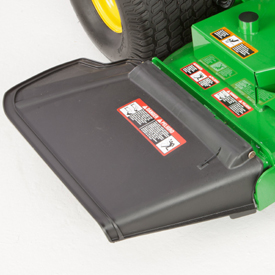 Flexible mower-discharge deflector
Flexible mower-discharge deflector
 Large, inset caster wheels
Large, inset caster wheels
The wide-discharge opening and raised deflector provide even clipping dispersal for an excellent finished appearance in all conditions.
Caster wheels with flat-free tires contribute to a smooth, even cutting job:
- Large, flat-free caster wheels carry the mower deck smoothly over the lawn.
- Caster wheels are recessed to reduce the vehicle footprint and turning radius.
- With the wheels less exposed, there is less chance they will get snagged by immovable obstacles, thus improving maneuverability and reducing damage.
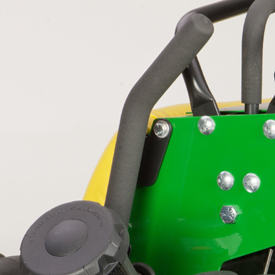 Mower lift lever (raised position)
Mower lift lever (raised position)
 Mower lift spring and lever (minimum cut-height position)
Mower lift spring and lever (minimum cut-height position)
The QuikTrak is equipped with a floating mower deck that offers several advantages over a fixed mower deck:
- The lift lever allows the operator to raise the mower to the full-up position from the operator's station.
- Convenient when transporting from one mowing area to another and when loading/unloading.
- Allows the operator to raise the mower over roots or other obstructions in the lawn on the fly.
- Lift-assist springs reduce the effort required to raise the mower deck.
 Cutting-height adjustment
Cutting-height adjustment
 Easy-to-remove mower deck shields
Easy-to-remove mower deck shields
Mower cutting height can be set from 1.5 in. (3.8 cm) to 5 in. (12.7 cm) in 0.25-in. (0.64-cm) increments:
- Pull the lift lever back to the fully-raised position.
- Remove the tethered pin and place it at the desired cutting height.
- Lower the lift lever; the lift lever and mower will stop at the desired cutting height.
Mower deck shields are easy to remove, with one knob, for access to the drive belt and other service points.
Optional mulching attachment
 Optional mulching attachment and blades (similar design shown)
Optional mulching attachment and blades (similar design shown)

Optional mulching attachment and special mulching blades are available:
-
This is a high-performance mulching attachment that includes formed steel baffles to control the material for superior performance.
-
The special mulching blades can also be used for side discharging, though overall cutting performance may be slightly less than with the standard blades.
Commercial-quality engine is reliable and provides excellent performance and life
 Engine
Engine
 Heavy-duty dual stage air cleaner
Heavy-duty dual stage air cleaner
A commercial-quality, 22-hp (16.4-kW) at 3600 rpm, air-cooled engine powers the QuikTrak™ Mower:
- Overhead valve design
- More horsepower and torque per cubic inch of displacement
- Better fuel efficiency
- Full-pressure lubrication with full-flow filter
-
Reduces engine wear by ensuring proper lubrication, even when operating on hillsides or uneven terrain
-
Filtered oil reduces risk of contamination for increased engine life
-
-
V-twin design
-
Fast starts
-
Smooth operation
-
- Vertical shaft for efficient transfer of power to the transmission and mower
- Standard dual-element, canister-type, dry replaceable, heavy-duty air cleaner with secondary safety element
- Fuel pump for consistent and reliable fuel supply to the carburetor
- Air-cooled engine design for minimum maintenance and maximum reliability
- Standard cleanout ports for easy access to remove debris collecting in cooling fins
- Aluminum cylinder block
- Effectively dissipates heat
- Lightweight and strong construction
- Extends engine life due to elimination of debilitating engine temperatures
 Engine oil-fill tube, filter, and drain
Engine oil-fill tube, filter, and drain

The engine is equipped with a replaceable oil filter for longer engine life.
Engine oil fill/check tube, oil filter, and oil drain are located close together for easy and convenient service.
Field-installed propane conversion kits for Commercial Walk-Behind Mowers, QuikTrak™ Mowers, and Commercial ZTrak™ Mowers
 Propane conversion kit on a Walk-Behind Mower
Propane conversion kit on a Walk-Behind Mower
 Propane conversion kit on a ZTrak Mower
Propane conversion kit on a ZTrak Mower
John Deere provides application-specific Environmental Protection Agency (EPA) approved field-installed propane conversion kits for specific John Deere Commercial Walk-Behind Mowers, QuikTrak Mowers, and ZTrak Mowers. The conversion kits include all components required to convert the engines to operate on propane fuel. Single-tank or dual-tank brackets (depending on the vehicle) are provided for securely holding the propane tank(s) to the vehicle.
Propane tanks are not included.
An optional altitude kit is required when operating at altitudes above 2000 ft (610 m). The operator’s manual with the propane conversion kit provides further details. Parts must be ordered separately through John Deere Parts.
Propane facts:
- Propane is flammable and commonly used as a fuel.
- The molecular formula of propane is C3H8, and it is in the family of liquefied petroleum gases (LP gases). The other LP gases include butane, propylene, butadiene, butylene, isobutylene, and mixtures thereof.
- Propane is commonly available and has proven to be a dependable, safe, economical, and clean-burning fuel. It can be used as household fuel, industrial fuel, and fuel for internal combustion engines. Propane has been used as a fuel since 1910.
- At atmospheric pressure, propane boils at -44°F (-42.2°C), meaning it typically exists as a vapor. However, when contained under pressure, such as in a propane cylinder, it can exist as a liquid.
- Propane is naturally odorless, but includes an additive odorant, usually mercaptan, which gives it a distinct odor.
- Vapor propane is heavier than air, meaning it will settle in low areas such as along the ground or in drains.
Advantages of John Deere propane conversion kits include:
- Reduced fuel costs, up to 30 percent depending on fuel prices
- Lower emissions
- Reduced fuel-system maintenance
- Maintains John Deere warranty
- EPA and CARB certified
- May qualify for national and state rebate and incentive programs. Please visit www.propane.com/commercial-landscape/programs-and-incentives/ for further information.
Propane tank mounting bracket options:
 Single propane tank shown on QuikTrak Mower
Single propane tank shown on QuikTrak Mower
 Dual propane tanks shown on ZTrak Mower
Dual propane tanks shown on ZTrak Mower
Optional tank configurations and sizes are available to provide operators the ability to tailor for run time:
- Commercial Walk-Behind Mowers have only a single-tank mounting option.
- The single-tank bracket is designed for one 20-lb (9.1-kg) or 33-lb (15-kg) Worthington tank.
- Tank is not included.
- The single-tank bracket is designed for one 20-lb (9.1-kg) or 33-lb (15-kg) Worthington tank.
- QuikTrak Mowers have single-tank and dual-tank mounting options.
- The single-tank, right-side bracket is designed for one 33-lb (15-kg) Worthington tank.
- Tank is not included.
- The dual-tank brackets are designed for two 20-lb (9.1-kg) Worthington tanks.
- Tanks are not included.
- The single-tank, right-side bracket is designed for one 33-lb (15-kg) Worthington tank.
- ZTrak Mowers have single-tank and dual-tank mounting options.
- The single-tank, left-side bracket is designed for one 33-lb (15-kg) or 43-lb (19.5-kg) Worthington tank.
- Tank is not included.
- The dual-tank brackets are designed for two 33-lb (15-kg) Worthington tanks.
- Tanks are not included.
- ZTrak Mowers with dual-tank configurations are not compatible with any material collection systems.
NOTE: Reference the Propane and Attachment Compatibility Chart to determine tank configurations that are compatible.
Estimated run-time comparison
| Engine displacement | FS603cc | FS726cc | FX726cc | FX852cc |
| Average consumption (lb [kg]/hr) | 3.9 (1.8) | 4.2 (1.9) | 4.2 (1.9) | 5.8 (2.6) |
| Run time (hours) with 20-lb (9.1-kg) tank | 5.1 | 4.8 | 4.8 | 3.4 |
| Run time (hours) with 33.5-lb (15.2-kg) tank | Not available | 8.0 | 8.0 | 5.8 |
| Run time (hours) with 43.5-lb (19.7-kg) tank | Not available | 10.4 | 10.4 | 7.5 |
Field-installed propane conversion kit compatibility:
NOTE: Conversion to propane is not intended for units with engines having more than 250 hours of use.
Commercial Walk-Behind Mowers (model year 2018 and prior)
| WG Series | WH Series | WHP Series | |||||||||
| Model | WG32A | WG36A | WG48A | WH36A | WH48A | WH52A | WH61A | WHP36A | WHP48A | WHP52A | WHP61A |
| Engine model | FS481V | FS481V | FS481V | FS481V | FS600V | FS600V | FS691V | FS481V | FS600V | FS600V | FS691V |
| Engine displacement | 603 cc | 603 cc | 603 cc | 603 cc | 603 cc | 603 cc | 726 cc | 603 cc | 603 cc | 603 cc | 726 cc |
| Propane kit model number | Not available | Not available | Not available | FS603cc | FS603cc | FS603cc | FS726cc | FS603cc | FS603cc | FS603cc | FS726cc |
QuikTrak Mowers
| E Series | M Series | R Series | |||||||
| Model | 652E | 636M | 648M | 652M | 648R | 652R | 652R EFI | 661R | 661R EFI |
| Engine model | FX691V | FS600V | FX691V | FX691V | FX691V | FX730V | ECV740 EFI | FX730V | ECV740 EFI |
| Engine displacement | 726 cc | 603 cc | 726 cc | 726 cc | 726 cc | 726 cc | 747 cc | 726 cc | 747 cc |
| Propane kit model number | FX726cc | Not available | Not available | Not available | FX726cc | FX726cc | Not available | FX726cc | Not available |
Commercial ZTrak Mowers
| E Series | M Series | R Series | |||||||||
| Model | Z915E | Z920M | Z930M | Z945M EFI | Z950M | Z955M EFI | Z960M | Z930R | Z950R | Z955R EFI | Z970R |
| Engine model | CV742 | FX730V | FX801V | ECV850 EFI | FX850V | ECV860J EFI | FX921V | FX801V | FX850V | ECV860J EFI | FX1000V |
| Engine displacement | 747 cc | 726 cc | 852 cc | 824 cc | 852 cc | 824 cc | 999 cc | 852 cc | 852 cc | 824 cc | 999 cc |
| Propane kit model number | Not available | FX726cc* | FX852cc* | Not available | FX852cc* | Not available | Not available | FX852cc* | FX852cc* | Not available | Not available |
Worthington tanks are manufactured by Worthington Industries, Inc.
Hydrostatic drive system is reliable and easy to use
 652R QuikTrak™ Mower mowing
652R QuikTrak™ Mower mowing
 Hydrostatic pumps
Hydrostatic pumps
QuikTrak Mowers use a heavy-duty hydrostatic pump and wheel-motor drive system that gives reliable and consistent performance and long life:
- Heavy-duty components stand up to the rigors of commercial use.
- Individual pump and wheel motor design allows placement of these heavy components low in the vehicle for a low center of gravity and excellent hillside stability.
Two Hydro-Gear™, 0.73 cu in. (12-cc), axial piston, variable-displacement pumps provide hydraulic power to the wheel motors:
- Rugged construction is ideal for high-performance commercial use.
- Piston design gives efficient and consistent performance.
- A replaceable hydraulic filter helps ensure long life of the pumps and wheel motors.
Two individual, 15-cu in. (245.8-cc), piston wheel motors power the QuikTrak drive wheels. Their heavy-duty construction and super-efficient axial-piston design provides superior performance and seamless power to the wheels:
- Integrated high-pressure shaft seal gives greater reliability.
- Large bearings are designed with the capacity to carry heavier loads and give long life.
 Transmission oil filter
Transmission oil filter
 Transmission fluid oil reservoir
Transmission fluid oil reservoir
A spin-on type replaceable hydraulic oil filter is conveniently located:
- Extends life of transmission components by keeping oil clean
- Easy-to-reach for easy and fast service
A hydraulic fluid oil reservoir is located behind the leaning pad:
- Located in a cleaner environment
- Easy to access for inspection and service
- Sight glass built into the tank reduces risk of contamination when checking fluid level.
 Transmission bypass valve
Transmission bypass valve
Transmission bypass valves are provided on each hydrostatic pump to permit moving the QuikTrak without the engine running.
Hydro-Gear is a trademark of Hydro-Gear Limited Partnership AF Holding Company.
Controls are easy to locate and use for operator comfort and productivity
 QuikTrak™ Mower mowing (652R shown)
QuikTrak™ Mower mowing (652R shown)
 Control console (652E shown)
Control console (652E shown)
Controls are color coded and logically placed to make them easy for the operator to find and use:
- Ground speed and direction are easily controlled by moving the two hand-lever hydrostatic drive controls forward or reverse.
- Speeds are infinitely variable up to 9.5 mph (15.3 km/h) forward and 5.5 mph (8.9 km/h) reverse.
- A positive neutral-lock position for the levers provides added safety.
- Two stationary reference bars are provided for operator convenience and security.
- Front reference bar is included to control speed and reduce fatigue from control lever operation.
- Rear reference bar is included to make reverse operation easy while maintaining operator confidence.
- Control levers return to neutral automatically for safety and convenience.
Separate choke is easy to locate and use.
- Less adjustment is needed with the separate choke.
 Brake lever (engaged position)
Brake lever (engaged position)
 Brake bar
Brake bar
A tire brake is provided to give stability for parking the vehicle on hillsides and for transport; it should be engaged whenever the machine is not being used:
- Brake must be engaged to start the machine, for added safety.
- The tire brake is easily adjusted, if necessary, to maintain effective operation.
Mower deck height-of-cut adjustment (648R, 652R, 661R)
 Mower deck lift handle (648R, 652R, 661R)
Mower deck lift handle (648R, 652R, 661R)
 Mower deck height-of-cut adjustment (648R, 652R, 661R)
Mower deck height-of-cut adjustment (648R, 652R, 661R)
On the 648R, 652R, 652R EFI, 661R, and 661R EFI QuikTrak Mowers, an easy-to-use cutting height adjustment system allows the operator to adjust the mower deck cutting height with no tools and minimal effort:
- Pull the lift lever back to the fully-raised position.
- Remove the tethered pin and place it at the desired cutting height.
- Lower the lift lever; the lift lever and mower will stop at the desired cutting height.
NOTE: Additional information on mower cutting height adjustment can be found in the mower deck section.
Safety features are built-in to protect the operator and bystanders
 652R QuikTrak™ Mower
652R QuikTrak™ Mower
 Mower discharge deflector
Mower discharge deflector
 Curb wheels
Curb wheels

Key safety features of QuikTrak Mowers include:
- Start circuit requirements
- Park brake engaged
- Power take-off (PTO) disengaged
- Control levers in neutral
- Ignition key used to start the engine
- A high-quality polyethylene mower-discharge deflector
- Deflects if it strikes a solid obstruction, causing less damage
- Returns to its original shape and function
- Operator station designed to allow fast exit
- Two large curb wheels
- Easy to remove and replace shields
- Stationary handles on either side of the traction controls for operator security
- Control levers return to neutral when released
Mower deck safety certification
QuikTrak mower decks are evaluated by the manufacturer (John Deere Turf Care) and conform to American National Standards Institute (ANSI) B71.4 2004 safety certification specifications for commercial turf care equipment.
Maintenance is simple and easy to reduce time and cost
 652E QuikTrak™ Mower
652E QuikTrak™ Mower
 Open engine compartment
Open engine compartment
All service components are easy to access:
- Servicing is simplified because of the open engine compartment.
- All service and maintenance points are within easy reach.
 Heavy-duty canister-type air cleaner
Heavy-duty canister-type air cleaner
 Engine oil fill/check tube and oil filter
Engine oil fill/check tube and oil filter
Canister-type heavy-duty air cleaner is easy to reach and easy to service:
- Air cleaner has two filter elements; a large outer filter and a smaller inner safety filter.
- Both filters are easy to access and easy to change.
Engine oil service points are grouped together in easy-to-reach locations:
- Reduces the time required to check and/or change the oil and filter.
 Leaning pad raised for service access
Leaning pad raised for service access
 Periodic service chart
Periodic service chart
Simply raising the leaning pad exposes the hydrostatic oil reservoir, control linkage and other service areas.
A periodic service chart is provided for convenience in keeping up on required service.
 Easy-to-remove access panel
Easy-to-remove access panel
 Hydrostatic transmission control linkage
Hydrostatic transmission control linkage
Remove service access shields on the mower deck, battery box, etc. to service the machine:
- Panels are easy to remove and install
Threaded ball and socket rod ends are used throughout the QuikTrak Mowers:
- Provide precise control over a long period of time
- Easily replaced when necessary
 Hydrostatic pump maintenance access
Hydrostatic pump maintenance access
 Transmission bypass valve
Transmission bypass valve
Access to check and service the hydrostatic pumps and motors is readily available at the rear of the machine.
Transmission bypass valves are located on the hydrostatic pumps to enable moving the vehicle without the engine running.
 Battery box
Battery box
 Battery cover removed for service access
Battery cover removed for service access
A secure battery box is provided to protect the battery, for reliable operation:
- Cover is easily removed for servicing the battery.
 Front tie down
Front tie down
 Rear tie down
Rear tie down
Four tie-down locations, two at the front and two at the rear, are provided for safely towing or anchoring the vehicle.
Michelin® X® Tweel® Turf rear tire solution for QuikTrak™ R Series Mowers eliminates downtime
 Tweel rear tire on QuikTrak Mower
Tweel rear tire on QuikTrak Mower
NOTE: 18x8.5N10 Tweel turf tires are available as an ordering option for QuikTrak 648R, 652R, 652R EFI, 661R, and 661R EFI Mowers. Tweels for QuikTrak Mowers are not available as base code equipment.
John Deere leads the commercial zero-turn mower industry with use of the Michelin X Tweel Turf technology for the QuikTrak Mowers.
Michelin is a world leader in tire manufacturing and technology. This airless radial tire solution is an industry first for John Deere, which provides an additional advantage to John Deere operators.
Advantages of the Michelin X Tweel Turf include:
- Mowing performance is improved.
- Unique energy transfer within the poly-resin spokes reduces the bounce associated with pneumatic tires.
- Excellent curb climbing due to the Michelin X Tweel Turf construction and flexibility.
- More consistent cut quality because inconsistent tire pressure is eliminated.
- Uptime is improved.
- The exclusive technology eliminates downtime and associated cost due to flat or damaged tires.
- Punctures and sidewall damage no longer result in downtime.
- Cost of operation is reduced.
- Cost of repairs and maintenance is reduced. One single unit replaces the current tire, wheel, and valve assembly. There is no need for complex tire-mounting equipment.
- No need to spend time checking and optimizing tire pressure.
- The need to purchase and stock plug kits and spare tires is eliminated, particularly for professional landscape contractors and government agencies who normally stock them.
- The tire tread will last up to three times longer than current pneumatic tires because automotive-grade rubber is used for the tread.
 Michelin X Tweel Turf
Michelin X Tweel Turf
 Michelin X Tweel Turf
Michelin X Tweel Turf
Heavy-duty construction provides the ultimate in performance and reliable operation:
- High-strength, poly-resin spokes carry the load.
- Four-hole, heavy-duty steel hub easily bolts onto any R Series QuikTrak Mower.
- Zero degree, high-tensile, proprietary carcass provides great lateral stiffness while resisting damage from impact and penetration.
Michelin, X, and Tweel are trademarks of Michelin North America, Inc.
Features
Compact design for easy hauling and excellent maneuverability
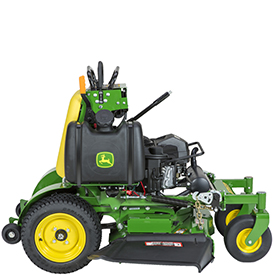 636M showing compact design
636M showing compact design
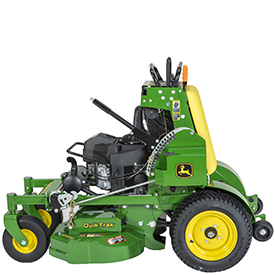 636M showing compact design
636M showing compact design
From the operator's platform to the mower deck, John Deere QuikTrak™ Mowers have a compact and functional design:
- The compact design allows the QuikTrak to operate in tighter areas that a larger machine cannot. Often, this means the area can be mowed with a QuikTrak so it is not necessary to switch to a walk-behind mower, which helps reduce the time on site.
- With the compact design of QuikTrak Mowers, less space is required on a truck or trailer - which can mean there is room for an extra mower, resulting in less time on property, saving time and money.
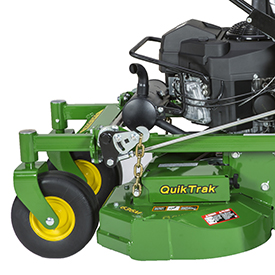 636M QuikTrak
636M QuikTrak
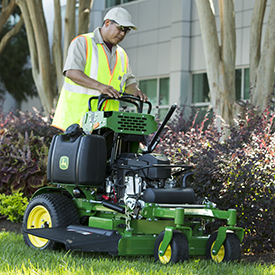 636M QuikTrak
636M QuikTrak
Whether mowing hills or on level terrain, trimming or mowing straight-away, the operator of a John Deere QuikTrak is able to affect the performance of the machine with their body:
- The compact design of the QuikTrak allows the operator to use their body to help control the machine.
The innovative QuikTrak design puts the operator in line with the rear axle to keep traction when mowing across slopes, providing greater control.
- Faster ground speeds get work done quicker.
- Better traction on slopes gives more control and increased productivity.
- Superior stability gives more control and confidence when operating.
- Better visibility allows for quick operator reaction times to changing terrain and obstructions.
- Standing area is designed for improved range of motion to allow the operator more room to move and avoid obstacles.
- Minimal operator station obstruction allows safe and fast exits for clearing mower-path obstacles.
- Operator area is designed for more comfort and less fatigue.
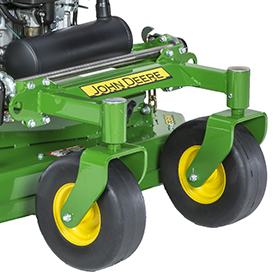 Inset caster wheels (636M shown)
Inset caster wheels (636M shown)
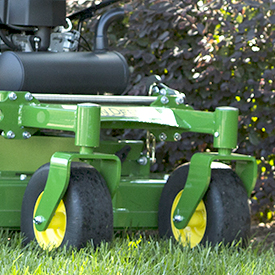 Inset caster wheels (636M shown)
Inset caster wheels (636M shown)
John Deere QuikTrak Mowers are designed, tested, and manufactured to provide the best commercial mowing machines available:
- Bull-nosed shape of the front edge of the mower deck allows caster wheels to be set back further, closer to the blades, for more effective ground following capability.
- Compact design takes less space for mowing tighter areas and may allow room for an extra machine when hauling to the worksite.
52-in. (132-cm) fabricated mower deck is made from 7-gauge, 0.179-in. (4.6-mm) steel for reliability and performance
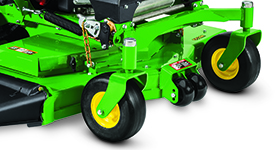 652M QuikTrak™ mower deck
652M QuikTrak™ mower deck
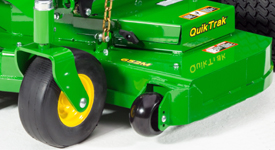 652M QuikTrak mower deck reinforcement
652M QuikTrak mower deck reinforcement
A well-designed mower deck can make the difference between just getting the job done and getting eye-catching results. The 7-gauge, 0.179-in. (4.6-mm) fabricated mower deck delivers an even higher quality of cut in even more diverse conditions to enhance mowing performance.
Key features of the fabricated mower deck include:
- The mower deck is manufactured from 7-gauge, 0.179-in. (4.6-mm) steel to minimize the number of welds and provide a smooth underside, with fewer sharp corners, for reduced material buildup.
- A compact footprint delivers greater maneuverability when working in tight quarters.
- A deep-deck design delivers excellent airflow so material is processed quickly and efficiently.
- A powerful vacuum effect is created by the deck's unique air-flow design, which pulls more grass upright so that the blades can cut more evenly.
- 48-in. to 61-in. (122-cm to 155-cm) decks come standard with an adjustable striping flap to enhance the after-cut appearance.
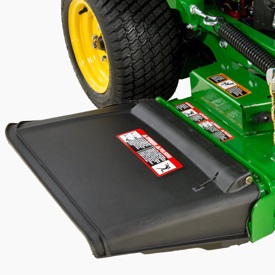 Flexible mower-discharge deflector
Flexible mower-discharge deflector
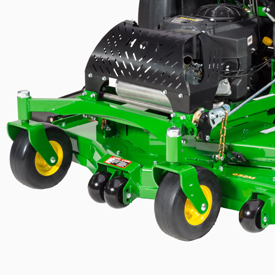 Large, inset caster wheels
Large, inset caster wheels
The wide-discharge opening and raised deflector provide even clipping dispersal for an excellent finished appearance in all conditions.
Caster wheels with flat-free tires contribute to a smooth, even cutting job:
- Large, flat-free caster wheels carry the mower deck smoothly over the lawn.
- Caster wheels are recessed to reduce the vehicle footprint and turning radius.
- With the wheels less exposed, there is less chance they will get snagged by immovable obstacles, thus improving maneuverability and reducing damage.
Anti-scalp rollers are double-captured for durability. They enable the deck to float over the ground and provide a smooth, level cut on even the most challenging terrain.
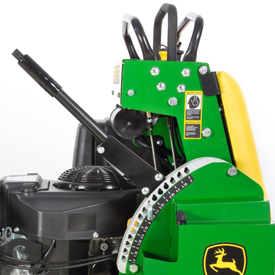 Mower lift lever (cutting position)
Mower lift lever (cutting position)
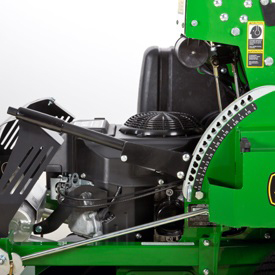 Mower lift spring and lever (minimum cut-height position)
Mower lift spring and lever (minimum cut-height position)
The QuikTrak is equipped with a floating mower deck that offers several advantages over a fixed mower deck:
- The lift lever allows the operator to raise the mower to the full-up position from the operator's station.
- Convenient when transporting from one mowing area to another and when loading/unloading.
- Allows the operator to raise the mower over roots or other obstructions in the lawn on the fly.
- Lift-assist springs reduce the effort required to raise the mower deck.
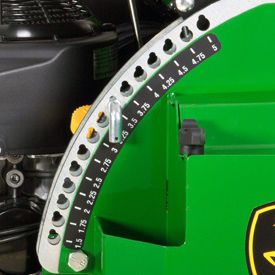 Cutting-height adjustment
Cutting-height adjustment
 Easy-to-remove mower deck shield
Easy-to-remove mower deck shield
Mower cutting height can be set from 1.5 in. (3.8 cm) to 5 in. (12.7 cm) in 0.25-in. (0.64-cm) increments:
- Pull the lift lever back to the fully-raised position.
- Remove the tethered pin and place it at the desired cutting height.
- Lower the lift lever; the lift lever and mower will stop at the desired cutting height.
Mower deck shields are easy to remove, with one knob, for access to the drive belt and other service points.
Optional mulching attachment
 Optional mulching attachment and blades (similar design shown)
Optional mulching attachment and blades (similar design shown)

Optional mulching attachment and special mulching blades are available:
-
This is a high-performance mulching attachment that includes formed steel baffles to control the material for superior performance.
-
The special mulching blades can also be used for side discharging, though overall cutting performance may be slightly less than with the standard blades.
Commercial-quality engine is reliable and provides excellent performance and life
 Engine (636M engine shown)
Engine (636M engine shown)
 Heavy-duty dual stage air cleaner (648M/652M engine shown)
Heavy-duty dual stage air cleaner (648M/652M engine shown)
A commercial-quality, 22-hp (16.4-kW) at 3600 rpm, air-cooled engine powers the QuikTrak™ Mower:
- Overhead valve design
- More horsepower and torque per cubic inch of displacement
- Better fuel efficiency
- Full-pressure lubrication with full-flow filter
-
Reduces engine wear by ensuring proper lubrication, even when operating on hillsides or uneven terrain
-
Filtered oil reduces risk of contamination for increased engine life
-
-
V-twin design
-
Fast starts
-
Smooth operation
-
- Vertical shaft for efficient transfer of power to the transmission and mower
- Standard dual-element, canister-type, dry replaceable, heavy-duty air cleaner with secondary safety element
- Fuel pump for consistent and reliable fuel supply to the carburetor
- Air-cooled engine design for minimum maintenance and maximum reliability
- Standard cleanout ports for easy access to remove debris collecting in cooling fins
- Aluminum cylinder block
- Effectively dissipates heat
- Lightweight and strong construction
- Extends engine life due to elimination of debilitating engine temperatures
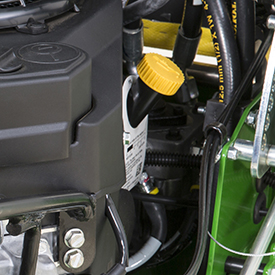 Engine oil-fill/check tube
Engine oil-fill/check tube
The engine is equipped with a replaceable oil filter for longer engine life.
Engine oil fill/check tube, oil filter, and oil drain are located close together for easy and convenient service.
Field-installed propane conversion kits for Commercial Walk-Behind Mowers, QuikTrak™ Mowers, and Commercial ZTrak™ Mowers
 Propane conversion kit on a Walk-Behind Mower
Propane conversion kit on a Walk-Behind Mower
 Propane conversion kit on a ZTrak Mower
Propane conversion kit on a ZTrak Mower
John Deere provides application-specific Environmental Protection Agency (EPA) approved field-installed propane conversion kits for specific John Deere Commercial Walk-Behind Mowers, QuikTrak Mowers, and ZTrak Mowers. The conversion kits include all components required to convert the engines to operate on propane fuel. Single-tank or dual-tank brackets (depending on the vehicle) are provided for securely holding the propane tank(s) to the vehicle.
Propane tanks are not included.
An optional altitude kit is required when operating at altitudes above 2000 ft (610 m). The operator’s manual with the propane conversion kit provides further details. Parts must be ordered separately through John Deere Parts.
Propane facts:
- Propane is flammable and commonly used as a fuel.
- The molecular formula of propane is C3H8, and it is in the family of liquefied petroleum gases (LP gases). The other LP gases include butane, propylene, butadiene, butylene, isobutylene, and mixtures thereof.
- Propane is commonly available and has proven to be a dependable, safe, economical, and clean-burning fuel. It can be used as household fuel, industrial fuel, and fuel for internal combustion engines. Propane has been used as a fuel since 1910.
- At atmospheric pressure, propane boils at -44°F (-42.2°C), meaning it typically exists as a vapor. However, when contained under pressure, such as in a propane cylinder, it can exist as a liquid.
- Propane is naturally odorless, but includes an additive odorant, usually mercaptan, which gives it a distinct odor.
- Vapor propane is heavier than air, meaning it will settle in low areas such as along the ground or in drains.
Advantages of John Deere propane conversion kits include:
- Reduced fuel costs, up to 30 percent depending on fuel prices
- Lower emissions
- Reduced fuel-system maintenance
- Maintains John Deere warranty
- EPA and CARB certified
- May qualify for national and state rebate and incentive programs. Please visit www.propane.com/commercial-landscape/programs-and-incentives/ for further information.
Propane tank mounting bracket options:
 Single propane tank shown on QuikTrak Mower
Single propane tank shown on QuikTrak Mower
 Dual propane tanks shown on ZTrak Mower
Dual propane tanks shown on ZTrak Mower
Optional tank configurations and sizes are available to provide operators the ability to tailor for run time:
- Commercial Walk-Behind Mowers have only a single-tank mounting option.
- The single-tank bracket is designed for one 20-lb (9.1-kg) or 33-lb (15-kg) Worthington tank.
- Tank is not included.
- The single-tank bracket is designed for one 20-lb (9.1-kg) or 33-lb (15-kg) Worthington tank.
- QuikTrak Mowers have single-tank and dual-tank mounting options.
- The single-tank, right-side bracket is designed for one 33-lb (15-kg) Worthington tank.
- Tank is not included.
- The dual-tank brackets are designed for two 20-lb (9.1-kg) Worthington tanks.
- Tanks are not included.
- The single-tank, right-side bracket is designed for one 33-lb (15-kg) Worthington tank.
- ZTrak Mowers have single-tank and dual-tank mounting options.
- The single-tank, left-side bracket is designed for one 33-lb (15-kg) or 43-lb (19.5-kg) Worthington tank.
- Tank is not included.
- The dual-tank brackets are designed for two 33-lb (15-kg) Worthington tanks.
- Tanks are not included.
- ZTrak Mowers with dual-tank configurations are not compatible with any material collection systems.
NOTE: Reference the Propane and Attachment Compatibility Chart to determine tank configurations that are compatible.
Estimated run-time comparison
| Engine displacement | FS603cc | FS726cc | FX726cc | FX852cc |
| Average consumption (lb [kg]/hr) | 3.9 (1.8) | 4.2 (1.9) | 4.2 (1.9) | 5.8 (2.6) |
| Run time (hours) with 20-lb (9.1-kg) tank | 5.1 | 4.8 | 4.8 | 3.4 |
| Run time (hours) with 33.5-lb (15.2-kg) tank | Not available | 8.0 | 8.0 | 5.8 |
| Run time (hours) with 43.5-lb (19.7-kg) tank | Not available | 10.4 | 10.4 | 7.5 |
Field-installed propane conversion kit compatibility:
NOTE: Conversion to propane is not intended for units with engines having more than 250 hours of use.
Commercial Walk-Behind Mowers (model year 2018 and prior)
| WG Series | WH Series | WHP Series | |||||||||
| Model | WG32A | WG36A | WG48A | WH36A | WH48A | WH52A | WH61A | WHP36A | WHP48A | WHP52A | WHP61A |
| Engine model | FS481V | FS481V | FS481V | FS481V | FS600V | FS600V | FS691V | FS481V | FS600V | FS600V | FS691V |
| Engine displacement | 603 cc | 603 cc | 603 cc | 603 cc | 603 cc | 603 cc | 726 cc | 603 cc | 603 cc | 603 cc | 726 cc |
| Propane kit model number | Not available | Not available | Not available | FS603cc | FS603cc | FS603cc | FS726cc | FS603cc | FS603cc | FS603cc | FS726cc |
QuikTrak Mowers
| E Series | M Series | R Series | |||||||
| Model | 652E | 636M | 648M | 652M | 648R | 652R | 652R EFI | 661R | 661R EFI |
| Engine model | FX691V | FS600V | FX691V | FX691V | FX691V | FX730V | ECV740 EFI | FX730V | ECV740 EFI |
| Engine displacement | 726 cc | 603 cc | 726 cc | 726 cc | 726 cc | 726 cc | 747 cc | 726 cc | 747 cc |
| Propane kit model number | FX726cc | Not available | Not available | Not available | FX726cc | FX726cc | Not available | FX726cc | Not available |
Commercial ZTrak Mowers
| E Series | M Series | R Series | |||||||||
| Model | Z915E | Z920M | Z930M | Z945M EFI | Z950M | Z955M EFI | Z960M | Z930R | Z950R | Z955R EFI | Z970R |
| Engine model | CV742 | FX730V | FX801V | ECV850 EFI | FX850V | ECV860J EFI | FX921V | FX801V | FX850V | ECV860J EFI | FX1000V |
| Engine displacement | 747 cc | 726 cc | 852 cc | 824 cc | 852 cc | 824 cc | 999 cc | 852 cc | 852 cc | 824 cc | 999 cc |
| Propane kit model number | Not available | FX726cc* | FX852cc* | Not available | FX852cc* | Not available | Not available | FX852cc* | FX852cc* | Not available | Not available |
Worthington tanks are manufactured by Worthington Industries, Inc.
Hydrostatic drive system is reliable and easy to use
 636M QuikTrak™ Mower mowing
636M QuikTrak™ Mower mowing
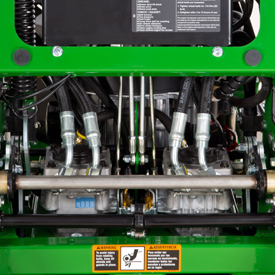 Hydrostatic pumps
Hydrostatic pumps
QuikTrak Mowers use a heavy-duty hydrostatic pump and wheel-motor drive system that gives reliable and consistent performance and long life:
- Heavy-duty components stand up to the rigors of commercial use.
- Individual pump and wheel motor design allows placement of these heavy components low in the vehicle for a low center of gravity and excellent hillside stability.
Two Hydro-Gear™, 0.61-cu in. (10-cc) axial piston, variable-displacement pumps provide hydraulic power to the wheel motors:
- Pumps are linked to the hand-control levers to allow the operator to make speed and direction changes.
- Rugged construction is ideal for high-performance commercial use.
- Piston design gives efficient and consistent performance.
- A replaceable hydraulic filter helps ensure long life of the pumps and wheel motors.
Two individual, 12-cu in. (196.6-cc), piston wheel motors power the QuikTrak drive wheels. Their heavy-duty construction and super-efficient axial-piston design provides superior performance and seamless power to the wheels:
- Integrated high-pressure shaft seal gives greater reliability.
- Large bearings are designed with the capacity to carry heavier loads and give long life.
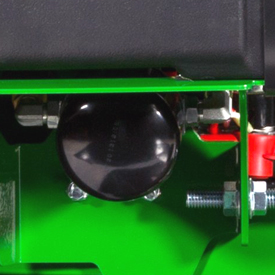 Transmission oil filter
Transmission oil filter
 Transmission fluid oil reservoir
Transmission fluid oil reservoir
A spin-on-type replaceable hydraulic oil filter is conveniently located:
- Extends life of transmission components by keeping oil clean
- Easy to reach for easy and fast service
A hydraulic fluid oil reservoir is located behind the leaning pad:
- Located in a cleaner environment
- Easy to access for inspection and service
- Sight glass built into the tank reduces risk of contamination when checking fluid level
Transmission bypass valves are provided on each hydrostatic pump to permit moving the QuikTrak without the engine running.
Hydro-Gear is a trademark of Hydro-Gear Limited Partnership AF Holding Company.
Controls are easy to locate and use for operator comfort and productivity
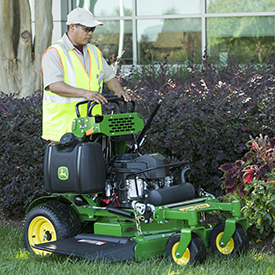 QuikTrak™ Mower mowing (636M shown)
QuikTrak™ Mower mowing (636M shown)
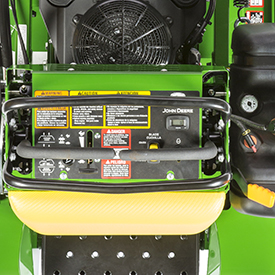 Control console (636M shown)
Control console (636M shown)
Controls are color coded and logically placed to make them easy for the operator to find and use:
- Ground speed and direction are easily controlled by moving the two hand-lever hydrostatic drive controls forward or reverse.
- Speeds are infinitely variable up to 8.2 mph (13.2 km/h) forward and 3.5 mph (5.6 km/h) reverse.
- A positive neutral-lock position for the levers provides added safety.
- Two stationary reference bars are provided for operator convenience and security.
- Front reference bar is included to control speed and reduce fatigue from control lever operation.
- Rear reference bar is included to make reverse operation easy while maintaining operator confidence.
- Control levers return to neutral automatically for safety and convenience.
- Separate choke is easy to locate and use.
- Less adjustment is needed with the separate choke.
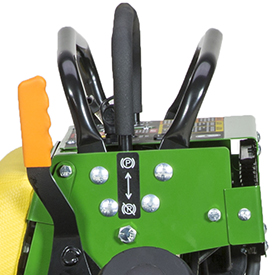 Brake lever (engaged position)
Brake lever (engaged position)
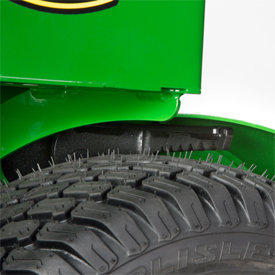 Brake bar
Brake bar
A tire brake is provided to give stability for parking the vehicle on hillsides and for transport; it should be engaged whenever the machine is not being used:
- Brake must be engaged to start the machine, for added safety.
- The tire brake bars are easily adjusted, if necessary, to maintain effective operation.
Mower deck height-of-cut adjustment
 Mower deck lift handle
Mower deck lift handle
 Mower deck height-of-cut adjustment
Mower deck height-of-cut adjustment
An easy-to-use cutting height adjustment system allows the operator to adjust the mower deck cutting height with no tools and minimal effort:
- Pull the lift lever back to the fully-raised position.
- Remove the tethered pin and place it at the desired cutting height.
- Lower the lift lever; the lift lever and mower will stop at the desired cutting height.
NOTE: Additional information on mower cutting height adjustment can be found in the mower deck section.
Safety features are built-in to protect the operator and bystanders
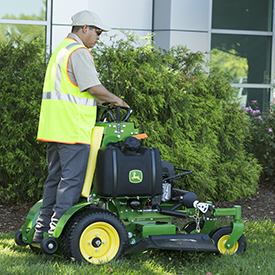 Operator trimming with 636M QuikTrak™ Mower
Operator trimming with 636M QuikTrak™ Mower
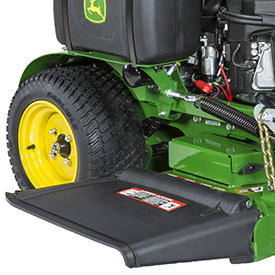 Mower discharge deflector
Mower discharge deflector
High-quality mower deflector directs cut clippings across the lawn for optimum appearance. Plastic material flexes if contacted to minimize damage.
 Operator controls
Operator controls
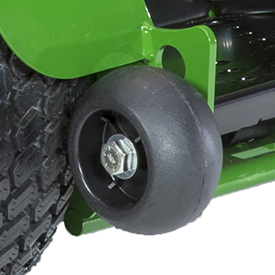 Curb wheels
Curb wheels
Key safety features of QuikTrak Mowers include:
- Start circuit requirements
- Park brake engaged
- Power take-off (PTO) disengaged
- Control levers in neutral
- Ignition key used to start the engine
- A high-quality, polyethylene, mower-discharge deflector
- Deflects if it strikes a solid obstruction, causing less damage
- Returns to its original shape and function
- Operator station designed to allow fast exit
- Two large curb wheels
- Easy to remove and replace shields
- Stationary handles on either side of the traction controls for operator security
- Control levers return to neutral when released
Mower deck safety certification
QuikTrak mower decks are evaluated by the manufacturer (John Deere Turf Care) and conform to American National Standards Institute (ANSI) B71.4 2004 safety certification specifications for commercial turf care equipment.
Maintenance is simple and easy to reduce time and cost
 636M QuikTrak™ Mower
636M QuikTrak™ Mower
 Open engine compartment
Open engine compartment
All service components are easy to access:
- Servicing is simplified because of the open engine compartment.
- All service and maintenance points are within easy reach.
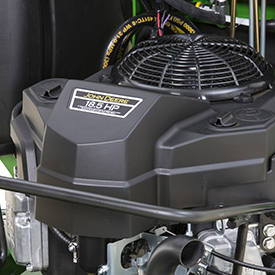 Dual-stage air cleaner
Dual-stage air cleaner
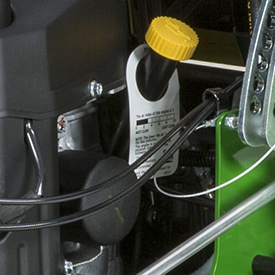 Engine oil fill/check tube and oil filter
Engine oil fill/check tube and oil filter
Dual-stage air cleaner is easy to reach and easy to service:
- Air cleaner has two filter elements.
- Element is easy to access and easy to change.
Engine oil service points are grouped together in easy-to-reach locations:
- Reduces the time required to check and/or change the oil and filter.
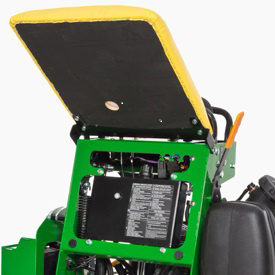 Leaning pad raised for service access
Leaning pad raised for service access
 Periodic service chart
Periodic service chart
Simply raising the leaning pad exposes the hydrostatic oil reservoir, control linkage, and other service areas.
A periodic service chart is provided for convenience in keeping up on required service.
 Easy-to-remove mower deck shield
Easy-to-remove mower deck shield
 Hydrostatic transmission control linkage
Hydrostatic transmission control linkage
Remove service access shields on the mower deck, battery box, etc. to service the machine:
- Panels are easy to remove and install.
Threaded ball and socket rod ends are used throughout the QuikTrak Mowers:
- Provide precise control over a long period of time
- Easily replaced when necessary
 Convenient access panel
Convenient access panel
 Hydrostatic pump maintenance access
Hydrostatic pump maintenance access
Access to check and service the hydrostatic pumps and motors is readily available at the rear of the machine.
Transmission bypass valves enable moving the vehicle without the engine running.
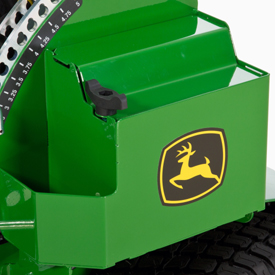 Battery box
Battery box
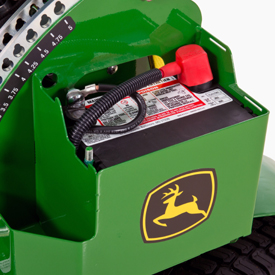 Battery cover removed for service access
Battery cover removed for service access
A secure battery box is provided to protect the battery, for reliable operation:
- Cover is easily removed for servicing the battery.
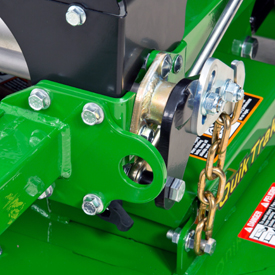 Front tie down
Front tie down
 Rear tie down
Rear tie down
Four tie-down locations, two at the front and two at the rear, are provided for safely towing or anchoring the vehicle.
Features
Compact design for easy hauling and excellent maneuverability
 636M showing compact design
636M showing compact design
 636M showing compact design
636M showing compact design
From the operator's platform to the mower deck, John Deere QuikTrak™ Mowers have a compact and functional design:
- The compact design allows the QuikTrak to operate in tighter areas that a larger machine cannot. Often, this means the area can be mowed with a QuikTrak so it is not necessary to switch to a walk-behind mower, which helps reduce the time on site.
- With the compact design of QuikTrak Mowers, less space is required on a truck or trailer - which can mean there is room for an extra mower, resulting in less time on property, saving time and money.
 636M QuikTrak
636M QuikTrak
 636M QuikTrak
636M QuikTrak
Whether mowing hills or on level terrain, trimming or mowing straight-away, the operator of a John Deere QuikTrak is able to affect the performance of the machine with their body:
- The compact design of the QuikTrak allows the operator to use their body to help control the machine.
The innovative QuikTrak design puts the operator in line with the rear axle to keep traction when mowing across slopes, providing greater control.
- Faster ground speeds get work done quicker.
- Better traction on slopes gives more control and increased productivity.
- Superior stability gives more control and confidence when operating.
- Better visibility allows for quick operator reaction times to changing terrain and obstructions.
- Standing area is designed for improved range of motion to allow the operator more room to move and avoid obstacles.
- Minimal operator station obstruction allows safe and fast exits for clearing mower-path obstacles.
- Operator area is designed for more comfort and less fatigue.
 Inset caster wheels (636M shown)
Inset caster wheels (636M shown)
 Inset caster wheels (636M shown)
Inset caster wheels (636M shown)
John Deere QuikTrak Mowers are designed, tested, and manufactured to provide the best commercial mowing machines available:
- Bull-nosed shape of the front edge of the mower deck allows caster wheels to be set back further, closer to the blades, for more effective ground following capability.
- Compact design takes less space for mowing tighter areas and may allow room for an extra machine when hauling to the worksite.
48-in. (122-cm) fabricated mower deck is made from 7-gauge, 0.179-in. (4.6-mm) steel for reliability and performance
 QuikTrak™ mower deck
QuikTrak™ mower deck
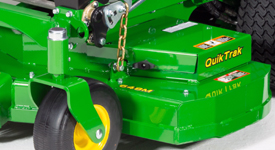 Mower deck reinforcement
Mower deck reinforcement
A well-designed mower deck can make the difference between just getting the job done and getting eye-catching results. The 7-gauge, 0.179-in. (4.6-mm) fabricated mower deck delivers a higher quality of cut in more diverse conditions to enhance mowing performance.
Key features of the fabricated mower deck include:
- The mower deck is manufactured from 7-gauge, 0.179-in. (4.6-mm) steel to minimize the number of welds and provide a smooth underside, with fewer sharp corners, for reduced material buildup.
- A compact footprint delivers greater maneuverability when working in tight quarters.
- A deep-deck design delivers excellent airflow so material is processed quickly and efficiently.
- A powerful vacuum effect is created by the deck's unique air-flow design, which pulls more grass upright so that the blades can cut more evenly.
- 48-in. to 61-in. (122-cm to 155-cm) decks come standard with an adjustable striping flap to enhance the after-cut appearance.
 Flexible mower-discharge deflector
Flexible mower-discharge deflector
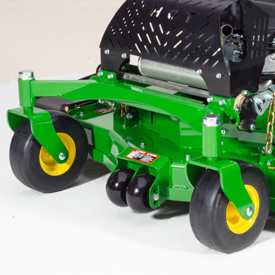 Large, inset caster wheels
Large, inset caster wheels
The wide-discharge opening and raised deflector provide even clipping dispersal for an excellent finished appearance in all conditions.
Caster wheels with flat-free tires contribute to a smooth, even cutting job:
- Large, flat-free caster wheels carry the mower deck smoothly over the lawn.
- Caster wheels are recessed to reduce the vehicle footprint and turning radius.
- With the wheels less exposed, there is less chance they will get snagged by immovable obstacles, thus improving maneuverability and reducing damage.
 Mower lift lever
Mower lift lever
The QuikTrak is equipped with a floating mower deck that offers several advantages over a fixed mower deck:
- The lift lever allows the operator to raise the mower to the fully-up position from the operator's station.
- Convenient when transporting from one mowing area to another and when loading/unloading.
- Allows the operator to raise the mower over roots or other obstructions in the lawn on the fly.
- Lift-assist springs reduce the effort required to raise the mower deck.
 Cutting-height adjustment
Cutting-height adjustment
 Easy-to-remove mower deck shields (652M shown)
Easy-to-remove mower deck shields (652M shown)
Mower cutting height can be set from 1.25 in. (3.2 cm) to 5 in. (12.7 cm) in 0.25-in. (0.64-cm) increments:
- Pull the lift lever back to the full-raised position.
- Remove the tethered pin and place it at the desired cutting height.
- Lower the lift lever; the lift lever and mower will stop at the desired cutting height.
Mower deck shields are easy to remove, with one knob, for access to the drive belt and other service points.
Optional mulching attachment
 Optional mulching attachment and blades (similar design shown)
Optional mulching attachment and blades (similar design shown)

Optional mulching attachment and special mulching blades are available:
-
This is a high-performance mulching attachment that includes formed steel baffles to control the material for superior performance.
-
The special mulching blades can also be used for side discharging, though overall cutting performance may be slightly less than with the standard blades.
Commercial-quality engine is reliable and provides excellent performance and life
 Engine (636M engine shown)
Engine (636M engine shown)
 Heavy-duty dual stage air cleaner (648M/652M engine shown)
Heavy-duty dual stage air cleaner (648M/652M engine shown)
A commercial-quality, 22-hp (16.4-kW) at 3600 rpm, air-cooled engine powers the QuikTrak™ Mower:
- Overhead valve design
- More horsepower and torque per cubic inch of displacement
- Better fuel efficiency
- Full-pressure lubrication with full-flow filter
-
Reduces engine wear by ensuring proper lubrication, even when operating on hillsides or uneven terrain
-
Filtered oil reduces risk of contamination for increased engine life
-
-
V-twin design
-
Fast starts
-
Smooth operation
-
- Vertical shaft for efficient transfer of power to the transmission and mower
- Standard dual-element, canister-type, dry replaceable, heavy-duty air cleaner with secondary safety element
- Fuel pump for consistent and reliable fuel supply to the carburetor
- Air-cooled engine design for minimum maintenance and maximum reliability
- Standard cleanout ports for easy access to remove debris collecting in cooling fins
- Aluminum cylinder block
- Effectively dissipates heat
- Lightweight and strong construction
- Extends engine life due to elimination of debilitating engine temperatures
 Engine oil-fill/check tube
Engine oil-fill/check tube
The engine is equipped with a replaceable oil filter for longer engine life.
Engine oil fill/check tube, oil filter, and oil drain are located close together for easy and convenient service.
Field-installed propane conversion kits for Commercial Walk-Behind Mowers, QuikTrak™ Mowers, and Commercial ZTrak™ Mowers
 Propane conversion kit on a Walk-Behind Mower
Propane conversion kit on a Walk-Behind Mower
 Propane conversion kit on a ZTrak Mower
Propane conversion kit on a ZTrak Mower
John Deere provides application-specific Environmental Protection Agency (EPA) approved field-installed propane conversion kits for specific John Deere Commercial Walk-Behind Mowers, QuikTrak Mowers, and ZTrak Mowers. The conversion kits include all components required to convert the engines to operate on propane fuel. Single-tank or dual-tank brackets (depending on the vehicle) are provided for securely holding the propane tank(s) to the vehicle.
Propane tanks are not included.
An optional altitude kit is required when operating at altitudes above 2000 ft (610 m). The operator’s manual with the propane conversion kit provides further details. Parts must be ordered separately through John Deere Parts.
Propane facts:
- Propane is flammable and commonly used as a fuel.
- The molecular formula of propane is C3H8, and it is in the family of liquefied petroleum gases (LP gases). The other LP gases include butane, propylene, butadiene, butylene, isobutylene, and mixtures thereof.
- Propane is commonly available and has proven to be a dependable, safe, economical, and clean-burning fuel. It can be used as household fuel, industrial fuel, and fuel for internal combustion engines. Propane has been used as a fuel since 1910.
- At atmospheric pressure, propane boils at -44°F (-42.2°C), meaning it typically exists as a vapor. However, when contained under pressure, such as in a propane cylinder, it can exist as a liquid.
- Propane is naturally odorless, but includes an additive odorant, usually mercaptan, which gives it a distinct odor.
- Vapor propane is heavier than air, meaning it will settle in low areas such as along the ground or in drains.
Advantages of John Deere propane conversion kits include:
- Reduced fuel costs, up to 30 percent depending on fuel prices
- Lower emissions
- Reduced fuel-system maintenance
- Maintains John Deere warranty
- EPA and CARB certified
- May qualify for national and state rebate and incentive programs. Please visit www.propane.com/commercial-landscape/programs-and-incentives/ for further information.
Propane tank mounting bracket options:
 Single propane tank shown on QuikTrak Mower
Single propane tank shown on QuikTrak Mower
 Dual propane tanks shown on ZTrak Mower
Dual propane tanks shown on ZTrak Mower
Optional tank configurations and sizes are available to provide operators the ability to tailor for run time:
- Commercial Walk-Behind Mowers have only a single-tank mounting option.
- The single-tank bracket is designed for one 20-lb (9.1-kg) or 33-lb (15-kg) Worthington tank.
- Tank is not included.
- The single-tank bracket is designed for one 20-lb (9.1-kg) or 33-lb (15-kg) Worthington tank.
- QuikTrak Mowers have single-tank and dual-tank mounting options.
- The single-tank, right-side bracket is designed for one 33-lb (15-kg) Worthington tank.
- Tank is not included.
- The dual-tank brackets are designed for two 20-lb (9.1-kg) Worthington tanks.
- Tanks are not included.
- The single-tank, right-side bracket is designed for one 33-lb (15-kg) Worthington tank.
- ZTrak Mowers have single-tank and dual-tank mounting options.
- The single-tank, left-side bracket is designed for one 33-lb (15-kg) or 43-lb (19.5-kg) Worthington tank.
- Tank is not included.
- The dual-tank brackets are designed for two 33-lb (15-kg) Worthington tanks.
- Tanks are not included.
- ZTrak Mowers with dual-tank configurations are not compatible with any material collection systems.
NOTE: Reference the Propane and Attachment Compatibility Chart to determine tank configurations that are compatible.
Estimated run-time comparison
| Engine displacement | FS603cc | FS726cc | FX726cc | FX852cc |
| Average consumption (lb [kg]/hr) | 3.9 (1.8) | 4.2 (1.9) | 4.2 (1.9) | 5.8 (2.6) |
| Run time (hours) with 20-lb (9.1-kg) tank | 5.1 | 4.8 | 4.8 | 3.4 |
| Run time (hours) with 33.5-lb (15.2-kg) tank | Not available | 8.0 | 8.0 | 5.8 |
| Run time (hours) with 43.5-lb (19.7-kg) tank | Not available | 10.4 | 10.4 | 7.5 |
Field-installed propane conversion kit compatibility:
NOTE: Conversion to propane is not intended for units with engines having more than 250 hours of use.
Commercial Walk-Behind Mowers (model year 2018 and prior)
| WG Series | WH Series | WHP Series | |||||||||
| Model | WG32A | WG36A | WG48A | WH36A | WH48A | WH52A | WH61A | WHP36A | WHP48A | WHP52A | WHP61A |
| Engine model | FS481V | FS481V | FS481V | FS481V | FS600V | FS600V | FS691V | FS481V | FS600V | FS600V | FS691V |
| Engine displacement | 603 cc | 603 cc | 603 cc | 603 cc | 603 cc | 603 cc | 726 cc | 603 cc | 603 cc | 603 cc | 726 cc |
| Propane kit model number | Not available | Not available | Not available | FS603cc | FS603cc | FS603cc | FS726cc | FS603cc | FS603cc | FS603cc | FS726cc |
QuikTrak Mowers
| E Series | M Series | R Series | |||||||
| Model | 652E | 636M | 648M | 652M | 648R | 652R | 652R EFI | 661R | 661R EFI |
| Engine model | FX691V | FS600V | FX691V | FX691V | FX691V | FX730V | ECV740 EFI | FX730V | ECV740 EFI |
| Engine displacement | 726 cc | 603 cc | 726 cc | 726 cc | 726 cc | 726 cc | 747 cc | 726 cc | 747 cc |
| Propane kit model number | FX726cc | Not available | Not available | Not available | FX726cc | FX726cc | Not available | FX726cc | Not available |
Commercial ZTrak Mowers
| E Series | M Series | R Series | |||||||||
| Model | Z915E | Z920M | Z930M | Z945M EFI | Z950M | Z955M EFI | Z960M | Z930R | Z950R | Z955R EFI | Z970R |
| Engine model | CV742 | FX730V | FX801V | ECV850 EFI | FX850V | ECV860J EFI | FX921V | FX801V | FX850V | ECV860J EFI | FX1000V |
| Engine displacement | 747 cc | 726 cc | 852 cc | 824 cc | 852 cc | 824 cc | 999 cc | 852 cc | 852 cc | 824 cc | 999 cc |
| Propane kit model number | Not available | FX726cc* | FX852cc* | Not available | FX852cc* | Not available | Not available | FX852cc* | FX852cc* | Not available | Not available |
Worthington tanks are manufactured by Worthington Industries, Inc.
Hydrostatic drive system is reliable and easy to use
 636M QuikTrak™ Mower mowing
636M QuikTrak™ Mower mowing
 Hydrostatic pumps
Hydrostatic pumps
QuikTrak Mowers use a heavy-duty hydrostatic pump and wheel-motor drive system that gives reliable and consistent performance and long life:
- Heavy-duty components stand up to the rigors of commercial use.
- Individual pump and wheel motor design allows placement of these heavy components low in the vehicle for a low center of gravity and excellent hillside stability.
Two Hydro-Gear™, 0.61-cu in. (10-cc) axial piston, variable-displacement pumps provide hydraulic power to the wheel motors:
- Pumps are linked to the hand-control levers to allow the operator to make speed and direction changes.
- Rugged construction is ideal for high-performance commercial use.
- Piston design gives efficient and consistent performance.
- A replaceable hydraulic filter helps ensure long life of the pumps and wheel motors.
Two individual, 12-cu in. (196.6-cc), piston wheel motors power the QuikTrak drive wheels. Their heavy-duty construction and super-efficient axial-piston design provides superior performance and seamless power to the wheels:
- Integrated high-pressure shaft seal gives greater reliability.
- Large bearings are designed with the capacity to carry heavier loads and give long life.
 Transmission oil filter
Transmission oil filter
 Transmission fluid oil reservoir
Transmission fluid oil reservoir
A spin-on-type replaceable hydraulic oil filter is conveniently located:
- Extends life of transmission components by keeping oil clean
- Easy to reach for easy and fast service
A hydraulic fluid oil reservoir is located behind the leaning pad:
- Located in a cleaner environment
- Easy to access for inspection and service
- Sight glass built into the tank reduces risk of contamination when checking fluid level
Transmission bypass valves are provided on each hydrostatic pump to permit moving the QuikTrak without the engine running.
Hydro-Gear is a trademark of Hydro-Gear Limited Partnership AF Holding Company.
Controls are easy to locate and use for operator comfort and productivity
 QuikTrak™ Mower mowing (636M shown)
QuikTrak™ Mower mowing (636M shown)
 Control console (636M shown)
Control console (636M shown)
Controls are color coded and logically placed to make them easy for the operator to find and use:
- Ground speed and direction are easily controlled by moving the two hand-lever hydrostatic drive controls forward or reverse.
- Speeds are infinitely variable up to 8.2 mph (13.2 km/h) forward and 3.5 mph (5.6 km/h) reverse.
- A positive neutral-lock position for the levers provides added safety.
- Two stationary reference bars are provided for operator convenience and security.
- Front reference bar is included to control speed and reduce fatigue from control lever operation.
- Rear reference bar is included to make reverse operation easy while maintaining operator confidence.
- Control levers return to neutral automatically for safety and convenience.
- Separate choke is easy to locate and use.
- Less adjustment is needed with the separate choke.
 Brake lever (engaged position)
Brake lever (engaged position)
 Brake bar
Brake bar
A tire brake is provided to give stability for parking the vehicle on hillsides and for transport; it should be engaged whenever the machine is not being used:
- Brake must be engaged to start the machine, for added safety.
- The tire brake bars are easily adjusted, if necessary, to maintain effective operation.
Mower deck height-of-cut adjustment
 Mower deck lift handle
Mower deck lift handle
 Mower deck height-of-cut adjustment
Mower deck height-of-cut adjustment
An easy-to-use cutting height adjustment system allows the operator to adjust the mower deck cutting height with no tools and minimal effort:
- Pull the lift lever back to the fully-raised position.
- Remove the tethered pin and place it at the desired cutting height.
- Lower the lift lever; the lift lever and mower will stop at the desired cutting height.
NOTE: Additional information on mower cutting height adjustment can be found in the mower deck section.
Safety features are built-in to protect the operator and bystanders
 Operator trimming with 636M QuikTrak™ Mower
Operator trimming with 636M QuikTrak™ Mower
 Mower discharge deflector
Mower discharge deflector
High-quality mower deflector directs cut clippings across the lawn for optimum appearance. Plastic material flexes if contacted to minimize damage.
 Operator controls
Operator controls
 Curb wheels
Curb wheels
Key safety features of QuikTrak Mowers include:
- Start circuit requirements
- Park brake engaged
- Power take-off (PTO) disengaged
- Control levers in neutral
- Ignition key used to start the engine
- A high-quality, polyethylene, mower-discharge deflector
- Deflects if it strikes a solid obstruction, causing less damage
- Returns to its original shape and function
- Operator station designed to allow fast exit
- Two large curb wheels
- Easy to remove and replace shields
- Stationary handles on either side of the traction controls for operator security
- Control levers return to neutral when released
Mower deck safety certification
QuikTrak mower decks are evaluated by the manufacturer (John Deere Turf Care) and conform to American National Standards Institute (ANSI) B71.4 2004 safety certification specifications for commercial turf care equipment.
Maintenance is simple and easy to reduce time and cost
 636M QuikTrak™ Mower
636M QuikTrak™ Mower
 Open engine compartment
Open engine compartment
All service components are easy to access:
- Servicing is simplified because of the open engine compartment.
- All service and maintenance points are within easy reach.
 Dual-stage air cleaner
Dual-stage air cleaner
 Engine oil fill/check tube and oil filter
Engine oil fill/check tube and oil filter
Dual-stage air cleaner is easy to reach and easy to service:
- Air cleaner has two filter elements.
- Element is easy to access and easy to change.
Engine oil service points are grouped together in easy-to-reach locations:
- Reduces the time required to check and/or change the oil and filter.
 Leaning pad raised for service access
Leaning pad raised for service access
 Periodic service chart
Periodic service chart
Simply raising the leaning pad exposes the hydrostatic oil reservoir, control linkage, and other service areas.
A periodic service chart is provided for convenience in keeping up on required service.
 Easy-to-remove mower deck shield
Easy-to-remove mower deck shield
 Hydrostatic transmission control linkage
Hydrostatic transmission control linkage
Remove service access shields on the mower deck, battery box, etc. to service the machine:
- Panels are easy to remove and install.
Threaded ball and socket rod ends are used throughout the QuikTrak Mowers:
- Provide precise control over a long period of time
- Easily replaced when necessary
 Convenient access panel
Convenient access panel
 Hydrostatic pump maintenance access
Hydrostatic pump maintenance access
Access to check and service the hydrostatic pumps and motors is readily available at the rear of the machine.
Transmission bypass valves enable moving the vehicle without the engine running.
 Battery box
Battery box
 Battery cover removed for service access
Battery cover removed for service access
A secure battery box is provided to protect the battery, for reliable operation:
- Cover is easily removed for servicing the battery.
 Front tie down
Front tie down
 Rear tie down
Rear tie down
Four tie-down locations, two at the front and two at the rear, are provided for safely towing or anchoring the vehicle.
Features
Compact design for easy hauling and excellent maneuverability
 636M showing compact design
636M showing compact design
 636M showing compact design
636M showing compact design
From the operator's platform to the mower deck, John Deere QuikTrak™ Mowers have a compact and functional design:
- The compact design allows the QuikTrak to operate in tighter areas that a larger machine cannot. Often, this means the area can be mowed with a QuikTrak so it is not necessary to switch to a walk-behind mower, which helps reduce the time on site.
- With the compact design of QuikTrak Mowers, less space is required on a truck or trailer - which can mean there is room for an extra mower, resulting in less time on property, saving time and money.
 636M QuikTrak
636M QuikTrak
 636M QuikTrak
636M QuikTrak
Whether mowing hills or on level terrain, trimming or mowing straight-away, the operator of a John Deere QuikTrak is able to affect the performance of the machine with their body:
- The compact design of the QuikTrak allows the operator to use their body to help control the machine.
The innovative QuikTrak design puts the operator in line with the rear axle to keep traction when mowing across slopes, providing greater control.
- Faster ground speeds get work done quicker.
- Better traction on slopes gives more control and increased productivity.
- Superior stability gives more control and confidence when operating.
- Better visibility allows for quick operator reaction times to changing terrain and obstructions.
- Standing area is designed for improved range of motion to allow the operator more room to move and avoid obstacles.
- Minimal operator station obstruction allows safe and fast exits for clearing mower-path obstacles.
- Operator area is designed for more comfort and less fatigue.
 Inset caster wheels (636M shown)
Inset caster wheels (636M shown)
 Inset caster wheels (636M shown)
Inset caster wheels (636M shown)
John Deere QuikTrak Mowers are designed, tested, and manufactured to provide the best commercial mowing machines available:
- Bull-nosed shape of the front edge of the mower deck allows caster wheels to be set back further, closer to the blades, for more effective ground following capability.
- Compact design takes less space for mowing tighter areas and may allow room for an extra machine when hauling to the worksite.
36-in. (91-cm) fabricated mower deck is made from 7-gauge, 0.179-in. (4.6-mm) steel for reliability and performance
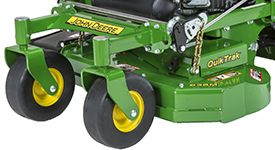 QuikTrak™ mower deck
QuikTrak™ mower deck
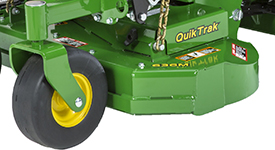 Mower-deck reinforcement
Mower-deck reinforcement
A well-designed mower deck can make the difference between just getting the job done and getting eye-catching results. The 7-gauge, 0.179-in. (4.6-mm) fabricated mower deck delivers a higher quality of cut in more diverse conditions to enhance mowing performance.
Key features of the fabricated mower deck include:
- The mower deck is manufactured from 7-gauge, 0.179-in. (4.6-mm) steel to minimize the number of welds and provide a smooth underside, with fewer sharp corners, for reduced material buildup.
- A compact footprint delivers greater maneuverability when working in tight quarters.
- A deep-deck design delivers excellent airflow so material is processed quickly and efficiently.
- A powerful vacuum effect is created by the deck's unique air-flow design, which pulls more grass upright so that the blades can cut more evenly.
 Flexible mower-discharge deflector
Flexible mower-discharge deflector
 Caster wheels
Caster wheels
The wide-discharge opening and raised deflector provide even clipping dispersal for an excellent finished appearance in all conditions.
Caster wheels with flat-free tires contribute to a smooth, even cutting job:
- Large, flat-free caster wheels carry the mower deck smoothly over the lawn.
- Caster wheels are recessed to reduce the vehicle footprint and turning radius.
- With the wheels less exposed, there is less chance they will get snagged by immovable obstacles, thus improving maneuverability and reducing damage.
 Mower lift lever (raised position)
Mower lift lever (raised position)
The QuikTrak is equipped with a floating mower deck that offers several advantages over a fixed mower deck:
- The lift lever allows the operator to raise the mower to the full-up position from the operator's station.
- Convenient when transporting from one mowing area to another and when loading/unloading.
- Allows the operator to raise the mower over roots or other obstructions in the lawn on the fly.
- Lift-assist springs reduce the effort required to raise the mower deck.
 Cutting-height adjustment
Cutting-height adjustment
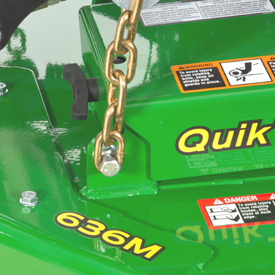 Easy-to-remove mower deck shields
Easy-to-remove mower deck shields
Mower cutting height can be set from 1.25 in. (3.2 cm) to 5 in. (12.7 cm) in 0.25-in. (0.64-cm) increments:
- Pull the lift lever back to the full-raised position.
- Remove the tethered pin and place it at the desired cutting height.
- Lower the lift lever; the lift lever and mower will stop at the desired cutting height.
Mower deck shields are easy to remove for access to the drive belt and other service points.
Optional mulching attachment
 Optional mulching attachment and blades (similar design shown)
Optional mulching attachment and blades (similar design shown)
Optional mulching attachment and special mulching blades are available:
-
This is a high-performance mulching attachment that includes formed steel baffles to control the material for superior performance.
-
The special mulching blades can also be used for side discharging, though overall cutting performance may be slightly less than with the standard blades.
Commercial-quality engine is reliable and provides excellent performance and life
 Engine
Engine
 Air cleaner access
Air cleaner access
A commercial-quality, 18.5-hp (13.8-kW) at 3600 rpm, air-cooled engine powers the QuikTrak™ Mower:
- Overhead valve design
- More horsepower and torque per cubic inch of displacement
- Better fuel efficiency
- Full-pressure lubrication with full-flow filter
-
Reduces engine wear by ensuring proper lubrication, even when operating on hillsides or uneven terrain
-
Filtered oil reduces risk of contamination for increased engine life
-
-
V-twin design
-
Fast starts
-
Smooth operation
-
- Vertical shaft for efficient transfer of power to the transmission and mower
- Standard dual-stage air cleaner
- Fuel pump for consistent and reliable fuel supply to the carburetor
- 50-state compliant engine, which complies with strict U.S. Environmental Protection Agency and California Air Resources Board emission standards without loss of horsepower or torque
- Air-cooled engine design for minimum maintenance and maximum reliability
- Standard cleanout ports for easy access to remove debris collecting in cooling fins.
- Aluminum cylinder block
- Effectively dissipates heat
- Lightweight and strong construction
- Extends engine life due to elimination of debilitating engine temperatures
 Engine oil-fill/check tube
Engine oil-fill/check tube
The engine is equipped with a replaceable oil filter for longer engine life.
Engine oil fill/check tube, oil filter, and oil drain are located close together for easy and convenient service.
Hydrostatic drive system is reliable and easy to use
 636M QuikTrak™ Mower mowing
636M QuikTrak™ Mower mowing
 Hydrostatic pumps
Hydrostatic pumps
QuikTrak Mowers use a heavy-duty hydrostatic pump and wheel-motor drive system that gives reliable and consistent performance and long life:
- Heavy-duty components stand up to the rigors of commercial use.
- Individual pump and wheel motor design allows placement of these heavy components low in the vehicle for a low center of gravity and excellent hillside stability.
Two Hydro-Gear™, 0.61-cu in. (10-cc) axial piston, variable-displacement pumps provide hydraulic power to the wheel motors:
- Pumps are linked to the hand-control levers to allow the operator to make speed and direction changes.
- Rugged construction is ideal for high-performance commercial use.
- Piston design gives efficient and consistent performance.
- A replaceable hydraulic filter helps ensure long life of the pumps and wheel motors.
Two individual, 12-cu in. (196.6-cc), piston wheel motors power the QuikTrak drive wheels. Their heavy-duty construction and super-efficient axial-piston design provides superior performance and seamless power to the wheels:
- Integrated high-pressure shaft seal gives greater reliability.
- Large bearings are designed with the capacity to carry heavier loads and give long life.
 Transmission oil filter
Transmission oil filter
 Transmission fluid oil reservoir
Transmission fluid oil reservoir
A spin-on-type replaceable hydraulic oil filter is conveniently located:
- Extends life of transmission components by keeping oil clean
- Easy to reach for easy and fast service
A hydraulic fluid oil reservoir is located behind the leaning pad:
- Located in a cleaner environment
- Easy to access for inspection and service
- Sight glass built into the tank reduces risk of contamination when checking fluid level
Transmission bypass valves are provided on each hydrostatic pump to permit moving the QuikTrak without the engine running.
Hydro-Gear is a trademark of Hydro-Gear Limited Partnership AF Holding Company.
Controls are easy to locate and use for operator comfort and productivity
 QuikTrak™ Mower mowing (636M shown)
QuikTrak™ Mower mowing (636M shown)
 Control console (636M shown)
Control console (636M shown)
Controls are color coded and logically placed to make them easy for the operator to find and use:
- Ground speed and direction are easily controlled by moving the two hand-lever hydrostatic drive controls forward or reverse.
- Speeds are infinitely variable up to 8.2 mph (13.2 km/h) forward and 3.5 mph (5.6 km/h) reverse.
- A positive neutral-lock position for the levers provides added safety.
- Two stationary reference bars are provided for operator convenience and security.
- Front reference bar is included to control speed and reduce fatigue from control lever operation.
- Rear reference bar is included to make reverse operation easy while maintaining operator confidence.
- Control levers return to neutral automatically for safety and convenience.
- Separate choke is easy to locate and use.
- Less adjustment is needed with the separate choke.
 Brake lever (engaged position)
Brake lever (engaged position)
 Brake bar
Brake bar
A tire brake is provided to give stability for parking the vehicle on hillsides and for transport; it should be engaged whenever the machine is not being used:
- Brake must be engaged to start the machine, for added safety.
- The tire brake bars are easily adjusted, if necessary, to maintain effective operation.
Mower deck height-of-cut adjustment
 Mower deck lift handle
Mower deck lift handle
 Mower deck height-of-cut adjustment
Mower deck height-of-cut adjustment
An easy-to-use cutting height adjustment system allows the operator to adjust the mower deck cutting height with no tools and minimal effort:
- Pull the lift lever back to the fully-raised position.
- Remove the tethered pin and place it at the desired cutting height.
- Lower the lift lever; the lift lever and mower will stop at the desired cutting height.
NOTE: Additional information on mower cutting height adjustment can be found in the mower deck section.
Safety features are built-in to protect the operator and bystanders
 Operator trimming with 636M QuikTrak™ Mower
Operator trimming with 636M QuikTrak™ Mower
 Mower discharge deflector
Mower discharge deflector
High-quality mower deflector directs cut clippings across the lawn for optimum appearance. Plastic material flexes if contacted to minimize damage.
 Operator controls
Operator controls
 Curb wheels
Curb wheels
Key safety features of QuikTrak Mowers include:
- Start circuit requirements
- Park brake engaged
- Power take-off (PTO) disengaged
- Control levers in neutral
- Ignition key used to start the engine
- A high-quality, polyethylene, mower-discharge deflector
- Deflects if it strikes a solid obstruction, causing less damage
- Returns to its original shape and function
- Operator station designed to allow fast exit
- Two large curb wheels
- Easy to remove and replace shields
- Stationary handles on either side of the traction controls for operator security
- Control levers return to neutral when released
Mower deck safety certification
QuikTrak mower decks are evaluated by the manufacturer (John Deere Turf Care) and conform to American National Standards Institute (ANSI) B71.4 2004 safety certification specifications for commercial turf care equipment.
Maintenance is simple and easy to reduce time and cost
 636M QuikTrak™ Mower
636M QuikTrak™ Mower
 Open engine compartment
Open engine compartment
All service components are easy to access:
- Servicing is simplified because of the open engine compartment.
- All service and maintenance points are within easy reach.
 Dual-stage air cleaner
Dual-stage air cleaner
 Engine oil fill/check tube and oil filter
Engine oil fill/check tube and oil filter
Dual-stage air cleaner is easy to reach and easy to service:
- Air cleaner has two filter elements.
- Element is easy to access and easy to change.
Engine oil service points are grouped together in easy-to-reach locations:
- Reduces the time required to check and/or change the oil and filter.
 Leaning pad raised for service access
Leaning pad raised for service access
 Periodic service chart
Periodic service chart
Simply raising the leaning pad exposes the hydrostatic oil reservoir, control linkage, and other service areas.
A periodic service chart is provided for convenience in keeping up on required service.
 Easy-to-remove mower deck shield
Easy-to-remove mower deck shield
 Hydrostatic transmission control linkage
Hydrostatic transmission control linkage
Remove service access shields on the mower deck, battery box, etc. to service the machine:
- Panels are easy to remove and install.
Threaded ball and socket rod ends are used throughout the QuikTrak Mowers:
- Provide precise control over a long period of time
- Easily replaced when necessary
 Convenient access panel
Convenient access panel
 Hydrostatic pump maintenance access
Hydrostatic pump maintenance access
Access to check and service the hydrostatic pumps and motors is readily available at the rear of the machine.
Transmission bypass valves enable moving the vehicle without the engine running.
 Battery box
Battery box
 Battery cover removed for service access
Battery cover removed for service access
A secure battery box is provided to protect the battery, for reliable operation:
- Cover is easily removed for servicing the battery.
 Front tie down
Front tie down
 Rear tie down
Rear tie down
Four tie-down locations, two at the front and two at the rear, are provided for safely towing or anchoring the vehicle.
Features
Compact design for easy hauling and excellent maneuverability
 Overhead view of 652E showing compact design
Overhead view of 652E showing compact design
 Side view of 652E showing compact design
Side view of 652E showing compact design
From the operator's platform to the mower deck, John Deere QuikTrak™ Mowers have a compact and functional design:
- The compact design allows the QuikTrak to operate in tighter areas that a larger machine cannot. Often, this means the area can be mowed with a QuikTrak so it is not necessary to switch to a walk-behind mower, reducing the time on site.
- With the compact design of QuikTrak Mowers, less space is required on a truck or trailer - which can mean there is room for an extra mower, resulting in less time on property, saving time and money.
 Mowing a tight area with 652R QuikTrak
Mowing a tight area with 652R QuikTrak
 652R QuikTrak
652R QuikTrak
Whether mowing hills or on level terrain, trimming or mowing straight-away, the operator of a John Deere QuikTrak is able to affect the performance of the machine with their body:
- The compact design of the QuikTrak allows the operator to use their body to help control the machine.
- The innovative QuikTrak design puts the operator in line with the rear axle to keep traction when mowing across slopes, providing greater control.
- Faster ground speeds get work done quicker.
- Better traction on slopes gives more control and increased productivity.
- Superior stability gives more control and confidence when mowing hillsides.
- Better visibility allows more-timely operator reaction to the terrain and obstructions.
- Standing area is designed for improved range of motion to allow the operator more room to move and avoid obstacles.
- Minimal operator-station obstruction allows safe and fast exits for clearing mower-path obstacles.
- Operator area is designed for more comfort and less fatigue.
 Inset caster wheels (652E shown)
Inset caster wheels (652E shown)
 Inset caster wheels (652R shown)
Inset caster wheels (652R shown)
John Deere QuikTrak Mowers are designed, tested, and manufactured to provide the best commercial mowing machines available:
- Bull-nosed shape of the front edge of the mower deck allows caster wheels to be set back further, closer to the blades, for more effective ground following capability.
- Compact design takes less space for mowing tighter areas and may allow room for an extra machine when hauling to the worksite.
52-in. (132-cm) fabricated, fixed mower deck is made from 7-gauge, 0.179-in. (4.6-mm) steel for reliability and performance
 652E QuikTrak™ Mower
652E QuikTrak™ Mower
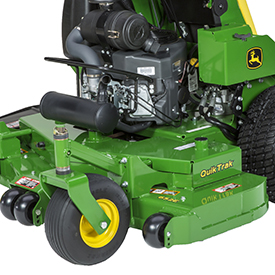 652E QuikTrak mower deck
652E QuikTrak mower deck
A well-designed mower deck can make the difference between just getting the job done and getting eye-catching results. The 7-gauge, 0.179-in. (4.6-mm) fabricated mower deck delivers a high-quality cut in more diverse conditions to enhance mowing performance.
Key features of the fabricated mower deck include:
- The mower deck is manufactured from 7-gauge, 0.179-in. (4.6-mm) steel.
- A compact footprint delivers greater maneuverability when working in tight quarters.
- A deep-deck design delivers excellent airflow so material is processed quickly and efficiently.
- A powerful vacuum effect is created by the deck's unique air-flow design, which pulls more grass upright so that the blades can cut more evenly.
- 48-in. to 61-in. (122-cm to 155-cm) decks come standard with an adjustable striping flap to enhance the after-cut appearance.
 Flexible mower-discharge deflector
Flexible mower-discharge deflector
 Large, inset caster wheels
Large, inset caster wheels
The wide-discharge opening and raised deflector provide even clipping dispersal for an excellent finished appearance in all conditions.
Caster wheels and anti-scalp rollers contribute to a smooth, even cutting job:
- Large, flat-free caster wheels carry the mower deck smoothly over the lawn.
- Caster wheels are recessed to reduce the vehicle footprint and turning radius.
- With the wheels less exposed, there is less chance they will get snagged by immovable obstacles, thus improving maneuverability and reducing damage.
- Anti-scalp rollers are double-captured for durability. They enable the deck to float over the ground and provide a smooth, level cut on even the most challenging terrain.
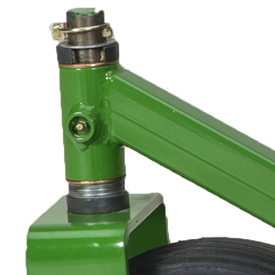 Easy cutting-height adjustment
Easy cutting-height adjustment
 Easy-to-remove mower deck shields
Easy-to-remove mower deck shields
A combination of shims and spacers can be used to set cutting height and level precisely:
- Gap in spacers allows them to be moved by just lowering the caster wheel; no need to remove it.
- Larger changes to cutting height can be made by changing the location of the support arm where it bolts to the mower deck.
Mower deck shields are easy to remove, with one knob, for access to the drive belt and other service points.
Optional mulching attachment
 Optional mulching attachment and blades (similar design shown)
Optional mulching attachment and blades (similar design shown)

Optional mulching attachment and special mulching blades are available:
-
This is a high-performance mulching attachment that includes formed steel baffles to control the material for superior performance.
-
The special mulching blades can also be used for side discharging, though overall cutting performance may be slightly less than with the standard blades.
Commercial-quality engine is reliable and provides excellent performance and life
 Engine
Engine
 Heavy-duty dual stage air cleaner
Heavy-duty dual stage air cleaner
A commercial-quality, 22-hp (16.4-kW) at 3600 rpm, air-cooled engine powers the QuikTrak™ Mower:
- Overhead valve design
- More horsepower and torque per cubic inch of displacement
- Better fuel efficiency
- Full-pressure lubrication with full-flow filter
-
Reduces engine wear by ensuring proper lubrication, even when operating on hillsides or uneven terrain
-
Filtered oil reduces risk of contamination for increased engine life
-
-
V-twin design
-
Fast starts
-
Smooth operation
-
- Vertical shaft for efficient transfer of power to the transmission and mower
- Standard dual-element, canister-type, dry replaceable, heavy-duty air cleaner with secondary safety element
- Fuel pump for consistent and reliable fuel supply to the carburetor
- Air-cooled engine design for minimum maintenance and maximum reliability
- Standard cleanout ports for easy access to remove debris collecting in cooling fins
- Aluminum cylinder block
- Effectively dissipates heat
- Lightweight and strong construction
- Extends engine life due to elimination of debilitating engine temperatures
 Engine oil-fill tube, filter, and drain
Engine oil-fill tube, filter, and drain

The engine is equipped with a replaceable oil filter for longer engine life.
Engine oil fill/check tube, oil filter, and oil drain are located close together for easy and convenient service.
Field-installed propane conversion kits for Commercial Walk-Behind Mowers, QuikTrak™ Mowers, and Commercial ZTrak™ Mowers
 Propane conversion kit on a Walk-Behind Mower
Propane conversion kit on a Walk-Behind Mower
 Propane conversion kit on a ZTrak Mower
Propane conversion kit on a ZTrak Mower
John Deere provides application-specific Environmental Protection Agency (EPA) approved field-installed propane conversion kits for specific John Deere Commercial Walk-Behind Mowers, QuikTrak Mowers, and ZTrak Mowers. The conversion kits include all components required to convert the engines to operate on propane fuel. Single-tank or dual-tank brackets (depending on the vehicle) are provided for securely holding the propane tank(s) to the vehicle.
Propane tanks are not included.
An optional altitude kit is required when operating at altitudes above 2000 ft (610 m). The operator’s manual with the propane conversion kit provides further details. Parts must be ordered separately through John Deere Parts.
Propane facts:
- Propane is flammable and commonly used as a fuel.
- The molecular formula of propane is C3H8, and it is in the family of liquefied petroleum gases (LP gases). The other LP gases include butane, propylene, butadiene, butylene, isobutylene, and mixtures thereof.
- Propane is commonly available and has proven to be a dependable, safe, economical, and clean-burning fuel. It can be used as household fuel, industrial fuel, and fuel for internal combustion engines. Propane has been used as a fuel since 1910.
- At atmospheric pressure, propane boils at -44°F (-42.2°C), meaning it typically exists as a vapor. However, when contained under pressure, such as in a propane cylinder, it can exist as a liquid.
- Propane is naturally odorless, but includes an additive odorant, usually mercaptan, which gives it a distinct odor.
- Vapor propane is heavier than air, meaning it will settle in low areas such as along the ground or in drains.
Advantages of John Deere propane conversion kits include:
- Reduced fuel costs, up to 30 percent depending on fuel prices
- Lower emissions
- Reduced fuel-system maintenance
- Maintains John Deere warranty
- EPA and CARB certified
- May qualify for national and state rebate and incentive programs. Please visit www.propane.com/commercial-landscape/programs-and-incentives/ for further information.
Propane tank mounting bracket options:
 Single propane tank shown on QuikTrak Mower
Single propane tank shown on QuikTrak Mower
 Dual propane tanks shown on ZTrak Mower
Dual propane tanks shown on ZTrak Mower
Optional tank configurations and sizes are available to provide operators the ability to tailor for run time:
- Commercial Walk-Behind Mowers have only a single-tank mounting option.
- The single-tank bracket is designed for one 20-lb (9.1-kg) or 33-lb (15-kg) Worthington tank.
- Tank is not included.
- The single-tank bracket is designed for one 20-lb (9.1-kg) or 33-lb (15-kg) Worthington tank.
- QuikTrak Mowers have single-tank and dual-tank mounting options.
- The single-tank, right-side bracket is designed for one 33-lb (15-kg) Worthington tank.
- Tank is not included.
- The dual-tank brackets are designed for two 20-lb (9.1-kg) Worthington tanks.
- Tanks are not included.
- The single-tank, right-side bracket is designed for one 33-lb (15-kg) Worthington tank.
- ZTrak Mowers have single-tank and dual-tank mounting options.
- The single-tank, left-side bracket is designed for one 33-lb (15-kg) or 43-lb (19.5-kg) Worthington tank.
- Tank is not included.
- The dual-tank brackets are designed for two 33-lb (15-kg) Worthington tanks.
- Tanks are not included.
- ZTrak Mowers with dual-tank configurations are not compatible with any material collection systems.
NOTE: Reference the Propane and Attachment Compatibility Chart to determine tank configurations that are compatible.
Estimated run-time comparison
| Engine displacement | FS603cc | FS726cc | FX726cc | FX852cc |
| Average consumption (lb [kg]/hr) | 3.9 (1.8) | 4.2 (1.9) | 4.2 (1.9) | 5.8 (2.6) |
| Run time (hours) with 20-lb (9.1-kg) tank | 5.1 | 4.8 | 4.8 | 3.4 |
| Run time (hours) with 33.5-lb (15.2-kg) tank | Not available | 8.0 | 8.0 | 5.8 |
| Run time (hours) with 43.5-lb (19.7-kg) tank | Not available | 10.4 | 10.4 | 7.5 |
Field-installed propane conversion kit compatibility:
NOTE: Conversion to propane is not intended for units with engines having more than 250 hours of use.
Commercial Walk-Behind Mowers (model year 2018 and prior)
| WG Series | WH Series | WHP Series | |||||||||
| Model | WG32A | WG36A | WG48A | WH36A | WH48A | WH52A | WH61A | WHP36A | WHP48A | WHP52A | WHP61A |
| Engine model | FS481V | FS481V | FS481V | FS481V | FS600V | FS600V | FS691V | FS481V | FS600V | FS600V | FS691V |
| Engine displacement | 603 cc | 603 cc | 603 cc | 603 cc | 603 cc | 603 cc | 726 cc | 603 cc | 603 cc | 603 cc | 726 cc |
| Propane kit model number | Not available | Not available | Not available | FS603cc | FS603cc | FS603cc | FS726cc | FS603cc | FS603cc | FS603cc | FS726cc |
QuikTrak Mowers
| E Series | M Series | R Series | |||||||
| Model | 652E | 636M | 648M | 652M | 648R | 652R | 652R EFI | 661R | 661R EFI |
| Engine model | FX691V | FS600V | FX691V | FX691V | FX691V | FX730V | ECV740 EFI | FX730V | ECV740 EFI |
| Engine displacement | 726 cc | 603 cc | 726 cc | 726 cc | 726 cc | 726 cc | 747 cc | 726 cc | 747 cc |
| Propane kit model number | FX726cc | Not available | Not available | Not available | FX726cc | FX726cc | Not available | FX726cc | Not available |
Commercial ZTrak Mowers
| E Series | M Series | R Series | |||||||||
| Model | Z915E | Z920M | Z930M | Z945M EFI | Z950M | Z955M EFI | Z960M | Z930R | Z950R | Z955R EFI | Z970R |
| Engine model | CV742 | FX730V | FX801V | ECV850 EFI | FX850V | ECV860J EFI | FX921V | FX801V | FX850V | ECV860J EFI | FX1000V |
| Engine displacement | 747 cc | 726 cc | 852 cc | 824 cc | 852 cc | 824 cc | 999 cc | 852 cc | 852 cc | 824 cc | 999 cc |
| Propane kit model number | Not available | FX726cc* | FX852cc* | Not available | FX852cc* | Not available | Not available | FX852cc* | FX852cc* | Not available | Not available |
Worthington tanks are manufactured by Worthington Industries, Inc.
Hydrostatic drive system is reliable and easy to use
 652E QuikTrak™ Mower
652E QuikTrak™ Mower
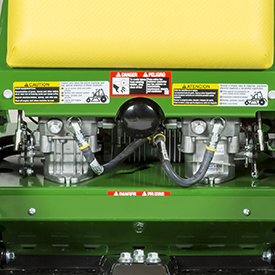 Hydrostatic pumps
Hydrostatic pumps
QuikTrak Mowers use a heavy-duty hydrostatic pump and wheel-motor drive system that gives reliable and consistent performance and long life:
- Heavy-duty components stand up to the stress of commercial use.
- Individual pump and wheel motor design allows placement of these heavy components low in the vehicle for a low center of gravity and excellent hillside stability.
Two Hydro-Gear™, 0.73-cu in. (12-cc) axial piston, variable-displacement pumps provide hydraulic power to the wheel motors:
- Pumps are linked to the hand-control levers to allow the operator to make speed and directional changes.
- Rugged construction is ideal for high-performance commercial use.
- Piston design gives efficient and consistent performance.
- A replaceable hydraulic filter helps ensure long life of the pumps and wheel motors.
Two individual, 15-cu in. (245.8-cc), piston wheel motors power the QuikTrak drive wheels. Their heavy-duty construction and super-efficient axial-piston design provides superior performance and seamless power to the wheels:
- Integrated high-pressure shaft seal gives greater reliability.
- Large bearings are designed with the capacity to carry heavier loads and give long life.
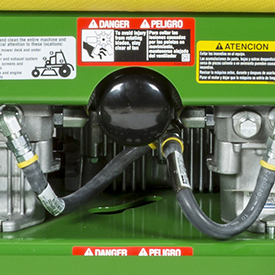 Transmission oil filter
Transmission oil filter
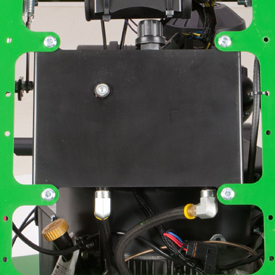 Transmission fluid oil reservoir
Transmission fluid oil reservoir
A spin-on type replaceable hydraulic oil filter is conveniently located:
- Extends life of transmission components by keeping oil clean
- Easy-to-reach for easy and fast service
A hydraulic fluid oil reservoir is located behind the leaning pad:
- Located in a cleaner environment
- Easy to access for inspection and service
- Sight glass built into the tank reduces risk of contamination when checking fluid level
 Transmission bypass valve
Transmission bypass valve
Transmission bypass valves are provided on each hydrostatic pump to permit moving the QuikTrak without the engine running.
Hydro-Gear is a trademark of Hydro-Gear Limited Partnership AF Holding Company.
Controls are easy to locate and use for operator comfort and productivity
 QuikTrak™ Mower mowing (652R shown)
QuikTrak™ Mower mowing (652R shown)
 Control console (652E shown)
Control console (652E shown)
Controls are color coded and logically placed to make them easy for the operator to find and use:
- Ground speed and direction are easily controlled by moving the two hand-lever hydrostatic drive controls forward or reverse.
- Speeds are infinitely variable up to 9.5 mph (15.3 km/h) forward and 5.5 mph (8.9 km/h) reverse.
- A positive neutral-lock position for the levers provides added safety.
- Two stationary reference bars are provided for operator convenience and security.
- Front reference bar is included to control speed and reduce fatigue from control lever operation.
- Rear reference bar is included to make reverse operation easy while maintaining operator confidence.
- Control levers return to neutral automatically for safety and convenience.
Separate choke is easy to locate and use.
- Less adjustment is needed with the separate choke.
 Brake lever (engaged position)
Brake lever (engaged position)
 Brake bar
Brake bar
A tire brake is provided to give stability for parking the vehicle on hillsides and for transport; it should be engaged whenever the machine is not being used:
- Brake must be engaged to start the machine, for added safety.
- The tire brake is easily adjusted, if necessary, to maintain effective operation.
Mower deck height-of-cut adjustment (648R, 652R, 661R)
 Mower deck lift handle (648R, 652R, 661R)
Mower deck lift handle (648R, 652R, 661R)
 Mower deck height-of-cut adjustment (648R, 652R, 661R)
Mower deck height-of-cut adjustment (648R, 652R, 661R)
On the 648R, 652R, 652R EFI, 661R, and 661R EFI QuikTrak Mowers, an easy-to-use cutting height adjustment system allows the operator to adjust the mower deck cutting height with no tools and minimal effort:
- Pull the lift lever back to the fully-raised position.
- Remove the tethered pin and place it at the desired cutting height.
- Lower the lift lever; the lift lever and mower will stop at the desired cutting height.
NOTE: Additional information on mower cutting height adjustment can be found in the mower deck section.
Safety features are built-in to protect the operator and bystanders
 652R QuikTrak™ Mower
652R QuikTrak™ Mower
 Mower discharge deflector
Mower discharge deflector
 Curb wheels
Curb wheels

Key safety features of QuikTrak Mowers include:
- Start circuit requirements
- Park brake engaged
- Power take-off (PTO) disengaged
- Control levers in neutral
- Ignition key used to start the engine
- A high-quality polyethylene mower-discharge deflector
- Deflects if it strikes a solid obstruction, causing less damage
- Returns to its original shape and function
- Operator station designed to allow fast exit
- Two large curb wheels
- Easy to remove and replace shields
- Stationary handles on either side of the traction controls for operator security
- Control levers return to neutral when released
Mower deck safety certification
QuikTrak mower decks are evaluated by the manufacturer (John Deere Turf Care) and conform to American National Standards Institute (ANSI) B71.4 2004 safety certification specifications for commercial turf care equipment.
Maintenance is simple and easy to reduce time and cost
 652E QuikTrak™ Mower
652E QuikTrak™ Mower
 Open engine compartment
Open engine compartment
All service components are easy to access:
- Servicing is simplified because of the open engine compartment.
- All service and maintenance points are within easy reach.
 Heavy-duty canister-type air cleaner
Heavy-duty canister-type air cleaner
 Engine oil fill/check tube and oil filter
Engine oil fill/check tube and oil filter
Canister-type heavy-duty air cleaner is easy to reach and easy to service:
- Air cleaner has two filter elements; a large outer filter and a smaller inner safety filter.
- Both filters are easy to access and easy to change.
Engine oil service points are grouped together in easy-to-reach locations:
- Reduces the time required to check and/or change the oil and filter.
 Leaning pad raised for service access
Leaning pad raised for service access
 Periodic service chart
Periodic service chart
Simply raising the leaning pad exposes the hydrostatic oil reservoir, control linkage and other service areas.
A periodic service chart is provided for convenience in keeping up on required service.
 Easy-to-remove access panel
Easy-to-remove access panel
 Hydrostatic transmission control linkage
Hydrostatic transmission control linkage
Remove service access shields on the mower deck, battery box, etc. to service the machine:
- Panels are easy to remove and install
Threaded ball and socket rod ends are used throughout the QuikTrak Mowers:
- Provide precise control over a long period of time
- Easily replaced when necessary
 Hydrostatic pump maintenance access
Hydrostatic pump maintenance access
 Transmission bypass valve
Transmission bypass valve
Access to check and service the hydrostatic pumps and motors is readily available at the rear of the machine.
Transmission bypass valves are located on the hydrostatic pumps to enable moving the vehicle without the engine running.
 Battery box
Battery box
 Battery cover removed for service access
Battery cover removed for service access
A secure battery box is provided to protect the battery, for reliable operation:
- Cover is easily removed for servicing the battery.
 Front tie down
Front tie down
 Rear tie down
Rear tie down
Four tie-down locations, two at the front and two at the rear, are provided for safely towing or anchoring the vehicle.
Features
Heavy-duty frame provides strength and durability
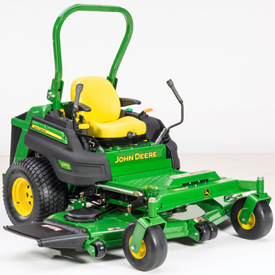 Z997R with 72-in. (183-cm) side-discharge mower
Z997R with 72-in. (183-cm) side-discharge mower

The durability features of the frame are as follows:
-
Heavy-duty, thick-gauge steel channel mainframe for strength and durability
-
Cast I-beam caster arms to handle the beating and pounding professional mowers receive
-
Wide-open access for maintenance and cleaning
Durable cast-iron rear bumper provides protection
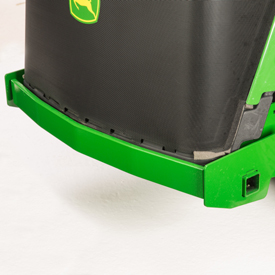 Cast-iron rear bumper
Cast-iron rear bumper
A cast-iron rear bumper is provided on the machine for rear protection. It also adds weight to give great hillside performance.
A rear hitch can be added to a 10-gauge, 0.135-in. (3.4-mm) steel bumper for towing purposes. ZTrak™ Z997R Mowers can tow up to 400 lb (181 kg).
Roll-Gard™ rollover protective structure for operator safety
 ROPS upright position
ROPS upright position
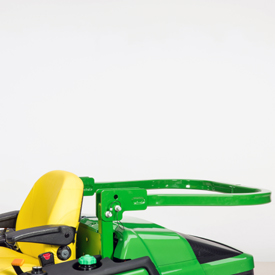 ROPS folded position
ROPS folded position
The foldable two-post rollover protective structure (ROPS) and seat belt are standard equipment to protect the operator in the event of machine tip-over. The ROPS structure meets U.S. Occupation Safety and Health Administration (OSHA) standard 1928.51. Retractable seat belts are within easy reach of the operator, for use when operating equipment with the ROPS up.
ROPS are foldable to allow trimming, such as under trees or bushes:
- To fold, remove two pins and rotate the top of the ROPS.
- Adjustment can be made from the operator's seat.
- ROPS must be in the upright and locked position when low clearance is not required; the use of seat belts is recommended when operating the equipment with ROPS in the upright position.
The folding ROPS performance is certified at the date of manufacture according to the following:
- USA OSHA: 1928.51 for North America and certification for the worldwide sales under OSHA.
ROPS stabilizer device
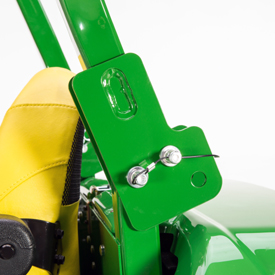 ROPS stabilizer device
ROPS stabilizer device
Stabilizers reduce the amount of movement and noise in the ROPS.
Michelin® X® Tweel® Turf airless radial tire technology option for a smoother ride and more uptime
 Michelin X Tweel Turf on Z997R
Michelin X Tweel Turf on Z997R
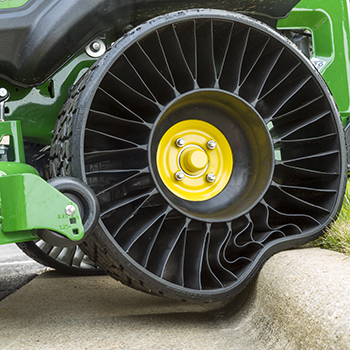 Flat-free rear tire on ZTrak™ Mower
Flat-free rear tire on ZTrak™ Mower
John Deere leads the commercial zero-turn mower industry with use of the Michelin X Tweel Turf technology.
Michelin is a world leader in tire manufacturing and technology. This airless radial tire solution is an industry first for John Deere, which provides a smoother ride for the operator and additional advantages to John Deere owners.
Advantages of the Michelin X Tweel Turf include:
- Mowing performance is improved.
- Unique energy transfer within the poly-resin spokes reduces the bounce associated with pneumatic tires, to give a smoother ride.
- Rutting is reduced because the Michelin X Tweel Turf has more support across the surface for improved flotation and better ground contact.
- Unique energy transfer within the poly-resin spokes reduces the bounce associated with pneumatic tires, to give a smoother ride.
- Excellent curb climbing is possible due to the Michelin X Tweel Turf construction and flexibility.
- More consistent cut quality is achieved because inconsistent tire pressure is eliminated.
- Uptime is improved.
- The exclusive technology eliminates downtime and associated cost due to flat or damaged tires. Punctures and sidewall damage no longer result in downtime.
- Cost of operation is reduced.
- Cost of repairs and maintenance is reduced. One single unit replaces the current tire, wheel, and valve assembly. There is no need for complex tire-mounting equipment.
- No need to spend time checking and optimizing tire pressure.
- The need to purchase and stock plug kits and spare tires is eliminated, particularly for professional landscape contractors and government agencies who normally stock them.
- The tire tread will last up to three times longer than current pneumatic tires because automotive-grade rubber is used for the tread.
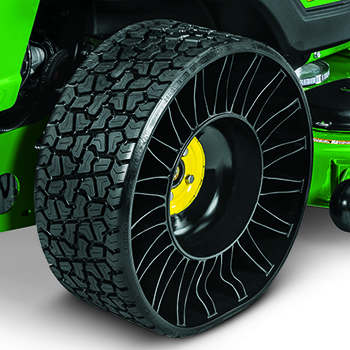 Michelin X Tweel Turf
Michelin X Tweel Turf
Heavy-duty construction provides the ultimate in performance and reliable operation:
- High-strength poly-resin spokes carry the load.
- Four-hole, heavy-duty steel hub easily bolts onto any Z997R ZTrak Mower.
- Deep, open-tread design provides excellent cleaning and traction.
- Zero degree, high-tensile proprietary carcass provides great lateral stiffness while resisting damage from impact and penetration.
Tires deliver exceptional traction, maneuverability, and reliability
 Run flat front caster wheel
Run flat front caster wheel
 Pneumatic rear drive wheel
Pneumatic rear drive wheel
The ZTrak Z997R Mower is equipped with 15x6-6 flat free front caster tires that provide:
- Excellent reliability and uptime
- Low center of gravity to increase hillside mowing capability
- Caster wheels and caster wheel towers with sealed bearings for long life and easy steering
- Offset front caster wheels to help improve the inside corner-trim performance and reduce between-blade striping
A choice of rear wheel options is available for factory installation:
- 26x12-12 4 PR pneumatic drive tires in base equipment for excellent traction, flotation, and curb climbing
- 26x12-12 Michelin X Tweel Turf airless radial tire technology option for a smoother ride and more uptime
Drive tires and caster wheels sized for proper weight distribution and traction
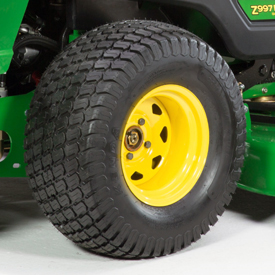 Turf drive tires
Turf drive tires
The Z997R comes with 26x12-12, square-shoulder, 4 PR turf drive tires as standard equipment.
Caster wheels
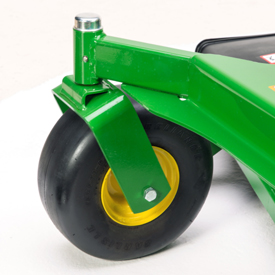 Caster wheels
Caster wheels
The 15x6-6 smooth-design flat-free front caster wheels provide excellent durability, flotation, and curb climbing.
A wide stance increases hillside mowing capability.
Michelin, X, and Tweel are trademarks of Michelin North America, Inc.
Powerful diesel engine for increased performance
 3-cylinder diesel engine
3-cylinder diesel engine
 Convenient access to engine
Convenient access to engine
The Z997R is powered by a 3-cylinder, liquid-cooled diesel engine with a gross 37.4 hp (27.5 kW) that meets U.S. Environmental Protection Agency (EPA) Final Tier 4 emission standards. The engine achieves Final Tier 4 compliance by using a diesel oxidation catalyst with diesel particulate filter (DOC/DPF) system.
The three-cylinder diesel engine features low noise levels, superior fuel economy, and a high torque reserve that provides plenty of power and performance.
Key features of the engine include:
- Economical, cast-in block cylinder design gives good cooling and long life.
- Liquid-cooled design provides more consistent operating temperatures than air-cooled.
- Direct fuel injection is provided.
- Injects fuel directly on top of pistons for more efficient combustion
- Develops more horsepower per gallon of fuel
- Improves starting
- Aluminum alloy pistons with built-in steel struts are lightweight to reduce connection rod bearing loads and provide good heat-transfer characteristics.
- Design permits tighter tolerances and neutralizes expansion of the piston, thereby reducing blow-by fuel and noise from the piston slap
- Higher top rings on the piston and a thinner head gasket greatly reduce the volume of unburned waste and increase combustion efficiency
- Timing gears and injector drive gears utilize helical profile gears to help lower engine noise.
- Gear teeth have a newly designed ''roll-off'' profile, giving almost no clash, no noise, and no backlash
- Fuel filter with replaceable element is provided.
- Full-pressure intake manifold provides quick starts in temperatures down to 0°F (-18°C).
- Auto-bleed fuel system gives extra convenience.
- No need to prime the system if the unit runs out of fuel; the system will self-prime the injection pump, lines and injectors, providing fast fuel recovery
- Key start and shutoff eliminates fuel shut-off knob; electric solenoid shuts fuel supply off immediately when key is turned off.
- See-through coolant recovery tank permits operator to check coolant level without removing radiator cap.
- Sealed radiator compartment keeps trash and debris on outside of hood.
- Dual-element, dry-type air cleaner with safety element and air service indicator is provided.
- Dual-element design for added engine protection
- Easy to service
- Completely sealed for effective cleaning and 90 to 95 percent of dirt ejected before it reaches the paper element
- Secondary safety element for additional filtering
- Air-restriction indicator to let operator know when the filter needs servicing
- Full-pressure lubrication with full-flow filter lengthens engine life.
- Engine wear reduced by ensuring proper lubrication, even when operating on hillsides or uneven terrain
- Oil filter helps keep oil clean for increased engine life
- Automotive-type alternator (75 amp) provides plenty of charge to the battery.
- Rear-mounted, covered radiator and fan keeps noise away from the operator and is easy to service.
- Isolated engine mounting reduces engine vibration at operator's station for more comfortable operation.
Air cleaner filters out dust to extend engine life
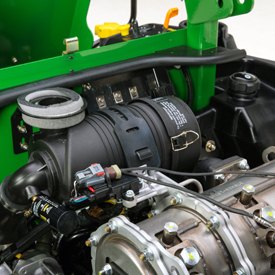 Engine air cleaner
Engine air cleaner
The ZTrak™ Z997R Diesel Mower is equipped with a dual-element, canister-style air filter that is easily accessible from the rear of the machine without tools.
- Filtration system pulls clean air from above the engine, in turn filtering out the dust that can damage an engine over time.
- Filters are easy to change when required.
- Pre-cleaner provides extra protection against contamination in dusty and dirty applications.
12-U.S. gal. (45.4-L) capacity fuel tank allows the operator to mow for a full day without refueling
 Fuel tank and fuel gauge
Fuel tank and fuel gauge
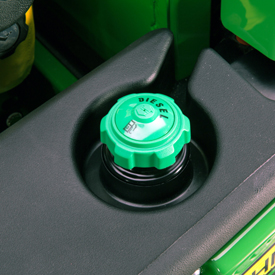 Diesel fuel cap
Diesel fuel cap
The Z997R Diesel ZTrak™ Mower is equipped with a single fuel tank, providing the following:
- 12-U.S. gal. (45.4-L) capacity allows the operator to mow for a full day without refueling.
- Large filler neck makes for easier refueling.
- Standard fuel gauge is provided.
- Top fuel draw provides added safety by reducing the chance fuel will leak out.
NOTE: The fill level is 1 in. (25 mm) below the bottom of the filler neck.
Quality drive system provides longer life and less maintenance
 Illustration of Kanzaki dual-unitized hydraulic pump
Illustration of Kanzaki dual-unitized hydraulic pump
The hydrostatic drive features a Kanzaki® DUP 17SB dual-unitized hydraulic pump. This dual pump, in a single housing, provides longer life and less maintenance than competitive units.
The pump features a shaft-driven fan for added cooling and longer component life. The swash-plate bearings are roller-type versus ball-type bearings for a longer overall pump life.
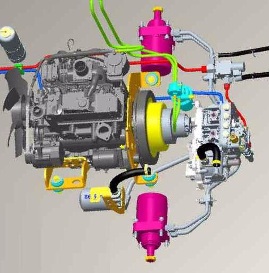 Illustration of transmission layout
Illustration of transmission layout
The transmission module integrates the dual pumps and steering valves in one single housing. The pump is shaft-driven from the engine. An isolator ensures reduced vibration between the engine and the transmission module.
Two wheel motors are installed on the chassis to directly transfer power to both wheels. Commercial-grade, heavy-duty TG0310 18.9-cu in. (310-cc) wheel motors from Parker Ross, part of the Hydraulic Pump & Motor Division of Parker Hannifin®, are also important components of the overall drive system efficiency.
Rigid hydraulic lines are installed between the hydraulic module and wheel motors for long life.
Kanzaki is a trademark of Kanzaki Kokyukoki Manufacturing Company. Parker Hannifin is a trademark of Parker Intangibles, LLC.
Standard operator comfort and convenience package for ease of use
 Operator platform
Operator platform
The Z997R Diesel ZTrak™ Mower is ergonomically designed to give the operator an enjoyable and comfortable ride while increasing productivity.
Two-lever hydrostatic drive control
- Commercial cutter can select the ground speed and direction control simply by moving levers forward or in reverse.
- Positive neutral lock position for levers provides added safety.
- Wide-bend steering levers swing out easily for entry and exit from the operator platform.
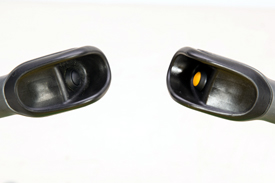 Comfort and convenience handles
Comfort and convenience handles
The comfort and convenience package includes large, ergonomically angled control levers with specially padded grips and built-in electronic controls to raise or lower the mower deck and disengage the mower blades.
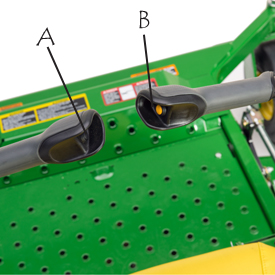 Control buttons
Control buttons
The push button (A) on the left motion control lever raises the mower deck. The push button (B) on the right-hand control lever shuts off the power take-off (PTO).
Once the PTO has been shut off using the button, the PTO switch must be pushed down and pulled up again to engage the PTO.
Easy to engage park-brake lever
 Park-brake lever
Park-brake lever
- Positive park position allows the operator to park on hillsides and lock the park brake during
trailer transport. - Park brake automatically disengages the machine during panic stop, for added safety.
Deluxe comfort seat is fully adjustable and includes ComfortGlide™ fore/aft suspension
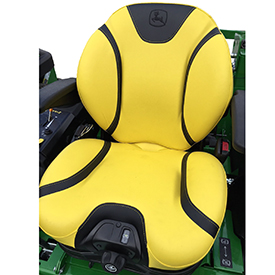 Suspension seat
Suspension seat
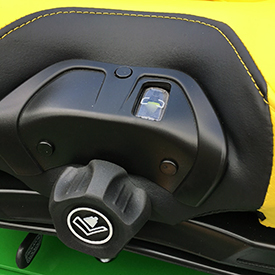 Seat adjustment controls
Seat adjustment controls
The deluxe comfort professional-grade seat is included in base equipment. It provides the operator with an enjoyable ride by allowing the operator the ability to adjust the seat to their preference. It includes:
- 24-in. (60.9-cm) high-back seat
- Suspension-reaction dial that adjusts vertical suspension for operator weight and a firm or soft ride
- Adjustable armrests
- Adjustable back angle
- ComfortGlide 2-in. (50.8-mm) fore/aft suspension to absorb bumps
- Vibration reduction
- 3-in. (7.6-cm) fore-aft adjustment while operator is seated
- Retractable seatbelt
 ComfortGlide fore/aft suspension control lever
ComfortGlide fore/aft suspension control lever
ComfortGlide fore/aft suspension gives superior ride comfort over uneven areas:
- Seat can travel up to 2 in. (50.8 mm) fore and aft to absorb bumps for a significant enhancement to ride comfort.
- Control lever provides the ability to easily lock out fore/aft suspension movement if desired.
- One lever has three functions.
- Slide seat forward and back 3 in. (10.2 cm) to allow the operator the ability to choose the leg room needed
- Activate Comfort Glide fore/aft seat suspension
- Lock out Comfort Glide fore/aft seat suspension
Mower deck height-of-cut adjustment is easy to use
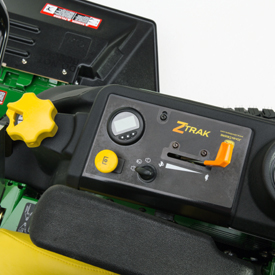 Control panel including height-of-cut adjustment dial
Control panel including height-of-cut adjustment dial
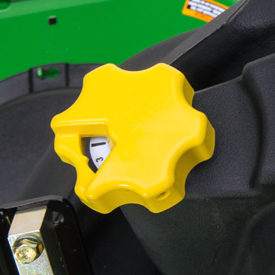 Height-of-cut adjustment dial
Height-of-cut adjustment dial
Single-touch deck lift system is best in class:
- No tool required for adjustments
- Dial-in knob used in conjunction with push button to change the height of cut
- Easy-to-use design for increased productivity by allowing change of cutting height from the seat
 Mower control buttons
Mower control buttons
The push button (A) on the left motion control lever raises the mower deck. The push button (B) on the right-hand control lever shuts off the power take-off (PTO).
Once the PTO has been shut off using the button, the PTO switch must be pushed down and pulled up again to engage the PTO.
Easily accessed daily service points mean less maintenance time and more working time
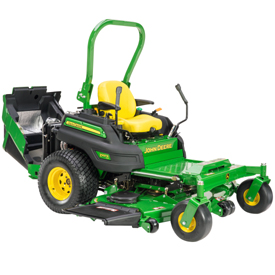 Easy serviceability
Easy serviceability
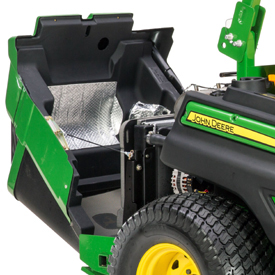 Rear hood open
Rear hood open
Service components are easy to see and access:
- Open engine compartment allows full access to engine components and service points.
- Engine heat is kept away from the operator.
- Flip-up seat allows easy access to the hydraulic system.
- Flip-out floor panel allows easy access to deck spindles.
Hood latch and hood pivots
 Hood latch
Hood latch
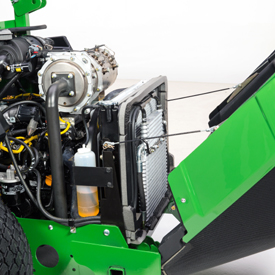 Hood opened for access to service points
Hood opened for access to service points
Hood has one central over-center type latch.
The hood pivots to make the hood easier to remove and install for ease of servicing the engine.
 Coolant reserve tank and oil filter
Coolant reserve tank and oil filter
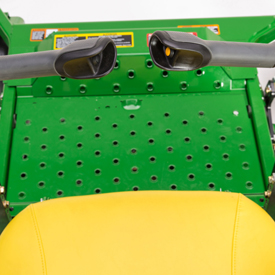 Flip-up deck service panel
Flip-up deck service panel
Three-year, bumper-to-bumper warranty
 Z955M ZTrak™ Mower
Z955M ZTrak™ Mower
 Z955R ZTrak Mower
Z955R ZTrak Mower
E and M Series 3-year, 1200-hour bumper-to-bumper warranty
An exclusive 2-year, unlimited hour/3-year, 1200-hour (whichever comes first) bumper-to-bumper warranty is standard for all John Deere E and M Series Mowers. The warranty is best in its class and places John Deere at the forefront of commercial mowing. It is also hassle free, with one company handling all of the paperwork.
NOTE: 36 months or 1200 hours, whichever comes first. For the first 24 months, there is no hour limitation.
R Series 3-year, 1500-hour bumper-to-bumper warranty
An exclusive 2-year, unlimited hour/3-year, 1500-hour (whichever comes first) bumper-to-bumper warranty is standard on all John Deere R Series mowers. The warranty is best in the industry and puts John Deere at the forefront of commercial mowing. It is also hassle free, with one company handling all of the paperwork.
NOTE: 36 months or 1500 hours, whichever comes first. For the first 24 months, there is no hour limitation.
Mower decks are safety certified
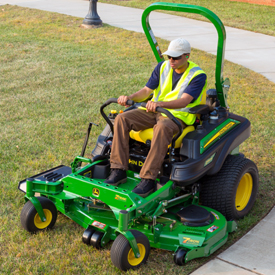 Z950M ZTrak Mower
Z950M ZTrak Mower
Mowers decks are evaluated by the manufacturer (John Deere Turf Care) and conform to American National Standards Institute (ANSI) B71.4 2004 safety certification specifications for commercial turf care equipment.
Four mower deck options for the Z997R give superior performance in every application
 Z997R shown with 60-in. (152-cm) 7-Iron™ PRO Mulch On Demand™ Mower Deck
Z997R shown with 60-in. (152-cm) 7-Iron™ PRO Mulch On Demand™ Mower Deck
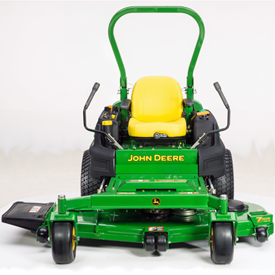 Z997R shown with 72-in. (183-cm) 7-Iron PRO side-discharge mower
Z997R shown with 72-in. (183-cm) 7-Iron PRO side-discharge mower
There are four mower-deck options available for the Z997R Diesel ZTrak™ Mower:
- The 60-in. (152-cm) 7-Iron PRO side-discharge deck is suited to a variety of mowing jobs, including trimming and grooming.
- The 60-in. (152-cm) 7-Iron PRO Mulch On Demand mower deck can be converted from a wide-open, side-discharge mode to a fully chambered mulching mode with a single move of a lever.
-
The 60-in. (152-cm) rear-discharge mower deck is fabricated from 7-gauge, 0.179-in. (4.5-mm) steel for added deck strength and long life. It is ideally suited for areas where people are present.
-
The 72-in. (183-cm) 7-Iron PRO side-discharge deck is suited to a variety of mowing jobs, including trimming and grooming on larger properties.
Spindle housings are made of ductile cast iron for extra durability
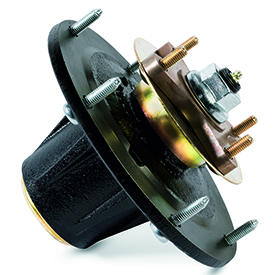 Cast-iron mower spindle
Cast-iron mower spindle
 Cast-iron mower spindle
Cast-iron mower spindle
On every commercial mower deck, there are three 1-in. (25-mm) spindles that are cold-forged and heat-treated for strength. Spindles are supported by precision ball bearings that provide great performance and reliability.
The blade spindles are designed for many hours of trouble-free operation:
- The spindle housings are made of ductile cast iron and have a gusseted design that puts the reinforcement where it is needed.
- Ductile cast-iron material provides increased impact strength.
- Strength of cast iron protects against damage from blade impacts.
- Grease fitting is mounted at the top for easy access.
- Grease pressure-relief valve minimizes seal damage from overfilling with grease and keeps debris from entering housing.
- The 8-in. (20.3-cm) diameter housing distributes loads and impacts to minimize deck-shell damage.
- Spindle assembly can be rebuilt.
60-in. (152-cm) 7-Iron PRO mower deck
 60 in. (152-cm) 7-Iron PRO mower deck shown
60 in. (152-cm) 7-Iron PRO mower deck shown
Features include:
- Higher blade tip speed - 18,000 fpm (5486 m/min) gives more blade strikes per distance of forward travel.
- Front baffle is designed to better manage airflow and control clippings.
- Ductile cast-iron blade-spindle housings have a gusseted design for extra reinforcement.
- Spindle-pocket reinforcement for even greater structural durability.
- A raised discharge chute provides even clipping distribution.
- 7-gauge, 0.179-in. (4.5-mm) steel construction gives commercial durability.
- 3-spindle design provides a smooth, even cut.
- Plastic discharge deflector reduces damage to foliage and resists bending.
- Formed, steel-deck design is stamped from a single sheet of steel to eliminate corners where grass can collect.
- Deep deck gives increased vacuum action that reduces dropped clippings.
- Shaft drive from engine to mower gives excellent reliability.
- Belt drive efficiently transfers power from gearbox to spindles.
- Grease fittings are greased from the top for easy access.
- Quick-change cutting-height adjustment is easy to use.
- Tricycler mulching kits are available.
- Blade overlap of 1.57 in. (40 mm), nearly 0.79 in. (20 mm) greater than previous decks, reduces the number of missed grass blades.
60-in. (152-cm) 7-Iron PRO Mulch On Demand Mower Deck
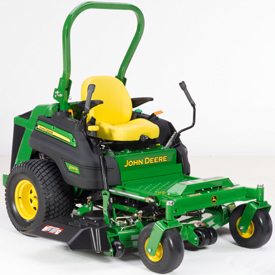 60-in. (152-cm) 7-Iron PRO Mulch On Demand Mower Deck shown
60-in. (152-cm) 7-Iron PRO Mulch On Demand Mower Deck shown
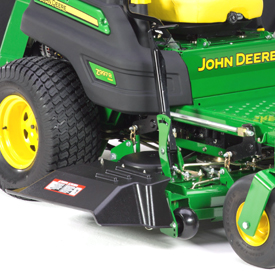 Mulch On Demand mower mulch control lever
Mulch On Demand mower mulch control lever
Key features of the 7-Iron PRO Mulch On Demand mower deck:
-
Deck can be converted from a wide-open side discharge mode to a fully chambered mulching mode with a single move of a lever.
-
Deck is stamped from 7-gauge, 0.179-in. (4.5-mm) steel to minimize the number of welds and provide a smooth underside, with fewer sharp corners, for reduced material buildup.
-
Significantly fewer welds on the deck shell to wear or break; it is stamped from a single sheet of steel rather than multiple fabrications. Anti-skid step on the deck provides easy machine mounting.
-
Higher blade tip speed than many competitors - 18,000 fpm (5486 m/min) for more blade cuts per inch mowed.
-
The rounded corners of the stamped deck help distribute impact stress to reduce the potential of damage when the mower contacts trees, rocks, curbs, and other fixed obstacles.
-
A deep-deck design of 5.5 in. (14 cm) delivers excellent airflow so material can be processed quickly and efficiently.
-
The wider and higher discharge opening provides even clipping dispersal for an excellent finished appearance in all conditions.
-
1-in. (25-mm) cold-forged spindles are heat-treated for strength and are supported by ball bearings, providing reliability and performance; ductile cast-iron blade-spindle housings have a gusseted design for extra reinforcement.
-
The front edge is raised above the blade plane to allow even cutting of tall grass and reinforced with a square bar for durability. The front baffle has been redesigned to better manage airflow and control clippings.
-
Dual-captured anti-scalp wheels provide deck flotation over even the toughest terrain.
60-in. (152-cm) rear-discharge mower deck
 60-in. (152-cm) rear-discharge mower deck
60-in. (152-cm) rear-discharge mower deck
The 60-in. (152-cm) rear-discharge mower is ideally suited for:
- Areas where people are present
- Schools
- Parks
- Playgrounds
- Traffic areas (city boulevards, roadsides, etc.)
- Conditions and application areas with long grass and weeds where wide dispersal of grass (park areas, roadsides, etc.) is not a concern
Some government bids specify that the mower is equipped with a rear discharge deck:
- Deck is fabricated from 7-gauge, 0.179-in. (4.5-mm) steel for added deck strength and long life.
- 0.75-in. (1.9-cm) solid steel bar is welded to the mower deck perimeter for additional strength.
- Deep-deck design increases airflow so more material can be processed.
- Operator can trim with either side.
- Unique baffling system that is designed to reduce clumping and windrowing usually associated with rear-discharge mowers.
- 1-in. to 5-in. (2.54-cm to 12.7-cm) cutting heights, in 0.5-in. (1.3-cm) increments, allow the operator to match mowing conditions.
- Gauge wheels, rollers, or side-mounted skid shoes lift the deck over uneven surfaces for a well-groomed appearance.
- Spindles can be greased without removing belt shields.
- 1-in. (25-mm) cold-forged spindles are reliable.
- Heat-treating of the spindles provides additional strength.
- Ductile cast-iron blade-spindle housings have a gusseted design for extra reinforcement.
72-in. (183-cm) 7-Iron PRO mower deck
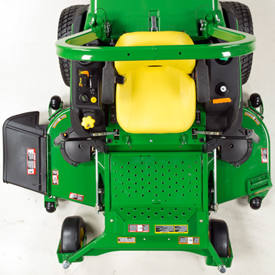 Z997R with 72-in. (183-cm) 7-Iron PRO mower
Z997R with 72-in. (183-cm) 7-Iron PRO mower
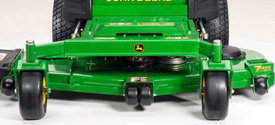 72-in. (183-cm) 7-Iron PRO mower deck
72-in. (183-cm) 7-Iron PRO mower deck
Features include:
- Higher blade tip speed - 18,000 fpm (5486 m/min) gives more blade strikes per distance of forward travel.
- Front baffle is designed to manage airflow and control clippings.
- Spindle pocket reinforcement gives greater structural durability.
- Ductile cast-iron blade-spindle housings have a gusseted design for extra reinforcement.
- A raised discharge chute provides even clipping distribution.
- 7-gauge, 0.179-in. (4.5-mm) steel construction gives commercial durability.
- 3-spindle design gives a smooth, even cut.
- Plastic discharge deflector reduces damage to foliage and resists bending.
- Formed, steel-deck design is stamped from a single sheet of steel to eliminate corners where grass can collect.
- Deep deck gives increased vacuum action that reduces dropped clippings.
- Shaft drive from engine to mower gives excellent reliability.
- Belt drive efficiently transfers power from gearbox to spindles.
- Grease fittings are greased from the top for easy access.
- Quick-change cutting-height adjustment is easy to use.
- Tricycler mulching kits are available.
- Blade overlap of 1.57 in. (40 mm), nearly 0.79 in. (20 mm) greater than previous decks, reduces the number of missed grass blades.
| 60-in. (152-cm) Side-Discharge |
60-in. (152-cm) Side-Discharge Mulch On Demand |
60-in. (152-cm) Rear-Discharge |
72-in. (183-cm) |
|
| Mower type | 7-Iron PRO - stamped deck | 7-Iron PRO - stamped deck | 7-gauge fabricated deck | 7-Iron PRO - stamped deck |
| Mower compatibility: | ||||
| Discharge | Side | Side | Rear | Side |
| Mulching capability | Optional field-installed kit | Standard Mulch On Demand included | Not available | Optional field-installed kit |
| Cut-height range | 1.5-5 in. (3.8-12.7 cm) |
1.5-5 in. (3.8-12.7 cm) |
1.5-5 in. (3.8-12.7 cm) |
1.5-5 in. (3.8-12.7 cm) |
| Cutting width | 60 in. (152 cm) | 60 in. (152 cm) | 60 in. (152 cm) | 72 in. (183 cm) |
| Height-of-cut adjustment | Turning knob with foot assist | Turning knob with foot assist | Turning knob with foot assist | Turning knob with foot assist |
| High lift blades: | ||||
| Blade length | 21 in. (53 cm) | 21 in. (53 cm) | 21 in. (53 cm) | 25 in. (64 cm) |
| Blade width | 3 in. (7.6 cm) | 3 in. (7.6 cm) | 3 in. (7.6 cm) | 3 in. (7.6 cm) |
| Blade thickness | 0.25 in. (6.35 mm) | 0.25 in. (6.35 mm) | 0.25 in. (6.35 mm) | 0.25 in. (6.35 mm) |
| Blade tip speed | 17,480 fpm (5.3 km/m) | 17,480 fpm (5.3 km/m) | 17,480 fpm (5.3 km/m) | 17,500 fpm (5.3 km/m) |
| Number of blades | Three | Three | Three | Three |
| Blade spindles: | ||||
| Bearings | Grade=ABEC-1 | Grade=ABEC-1 | Grade=ABEC-1 | Grade=ABEC-1 |
| Spindles | Cold-forged and heat-treated | Cold-forged and heat-treated | Cold-forged and heat-treated | Cold-forged and heat-treated |
| Spindle housings | Ductile cast-iron | Ductile cast-iron | Ductile cast-iron | Ductile cast-iron |
| Wheels: | ||||
| Front anti-scalp rollers | Standard | Standard | Standard | Standard |
| Rear anti-scalp rollers | Standard | Standard | Standard | Standard |
| Deck construction | One-piece stamped steel | One-piece stamped steel | Fabricated steel | One-piece stamped steel |
| Deck thickness | 7-gauge steel 0.179 in. (4.5 mm) |
7-gauge steel |
7-gauge steel |
7-gauge steel |
NOTE: The 60-in. (152-cm) 7-Iron PRO Mulch On Demand mower deck is not available in Australia/New Zealand.
Mower decks are safety certified
 Z950M ZTrak Mower
Z950M ZTrak Mower
Mowers decks are evaluated by the manufacturer (John Deere Turf Care) and conform to American National Standards Institute (ANSI) B71.4 2004 safety certification specifications for commercial turf care equipment.
Features
Heavy-duty chassis components provide strength and durability
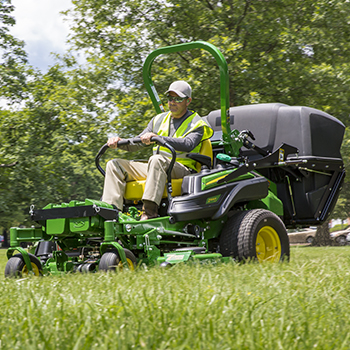 Z994R ZTrak™ Mower with optional dump-from-seat material collection system
Z994R ZTrak™ Mower with optional dump-from-seat material collection system
 Z994R ZTrak Mower
Z994R ZTrak Mower
Attractive styling incorporates a roomy and uncluttered operator platform with adjustable footrest, seat, and steering control positions for different operator preferences. Other well-thought-out features further contribute to good looks and operator comfort.
The frame is made of heavy-duty formed and welded steel for strength and reliability.
Formed and welded steel frame
 Z994R ZTrak Mower
Z994R ZTrak Mower
 Z994R ZTrak Mower
Z994R ZTrak Mower
A strong, welded steel frame provides solid, reliable support for the machine components and operator:
- Heavy-duty, 7-gauge, 0.179-in. (4.55-mm) 1.5x3-in. (38x76.2-mm) steel tubular frame for durability
- Wide-open access for maintenance and cleaning
- Rear frame provides solid support and protection for the engine
Front axle and offset caster wheels
 Front axle and caster wheels
Front axle and caster wheels
Cast I-beam caster arm and spindle assemblies handle the beating and pounding professional mowers receive.
Caster wheels are offset for optimum steering and mowing performance. Benefits include better inside-corner trimming performance and less chance of between-blade striping.
Rear bumper provides protection
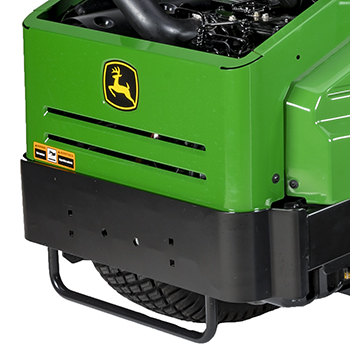 Z994R rear bumper
Z994R rear bumper
 Optional rear hitch
Optional rear hitch
A steel rear bumper provides protection for the machine.
A rear hitch can be added to the steel bumper for towing purposes. The Z994R can tow up to 400 lb (181.4 kg).
Michelin® X® Tweel® Turf airless radial tire technology option for a smoother ride and more uptime
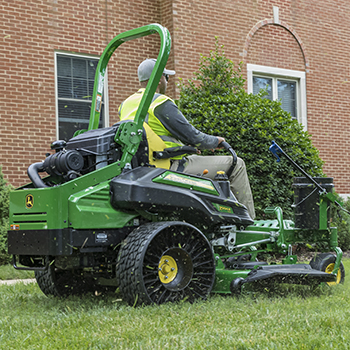 Michelin X Tweel Turf on Z994R
Michelin X Tweel Turf on Z994R
 Flat-free rear tire on ZTrak™ Mower
Flat-free rear tire on ZTrak™ Mower
John Deere leads the commercial zero-turn mower industry with use of the Michelin X Tweel Turf technology.
Michelin is a world leader in tire manufacturing and technology. This airless radial tire solution is an industry first for John Deere, which provides a smoother ride for the operator and additional advantages to John Deere owners.
Advantages of the Michelin X Tweel Turf include:
- Mowing performance is improved.
- Rutting is reduced because the Michelin X Tweel Turf has more support across the surface for improved flotation and better ground contact.
- Unique energy transfer within the poly-resin spokes reduces the bounce associated with pneumatic tires, to give a smoother ride.
- Excellent curb climbing is possible due to the Michelin X Tweel Turf construction and flexibility.
- More consistent cut quality is achieved because inconsistent tire pressure is eliminated.
- Uptime is improved.
- The exclusive technology eliminates downtime and associated cost due to flat or damaged tires. Punctures and sidewall damage no longer result in downtime.
- Cost of operation is reduced.
- Cost of repairs and maintenance is reduced. One single unit replaces the current tire, wheel, and valve assembly. There is no need for complex tire-mounting equipment.
- No need to spend time checking and optimizing tire pressure.
- The need to purchase and stock plug kits and spare tires is eliminated, particularly for professional landscape contractors and government agencies who normally stock them.
- The tire tread will last up to three times longer than current pneumatic tires because automotive-grade rubber is used for the tread.
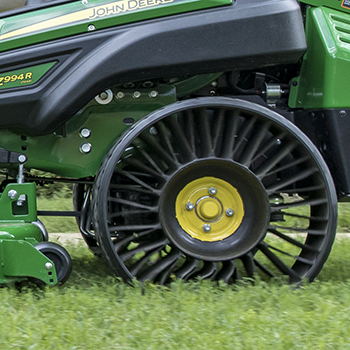 Michelin X Tweel Turf
Michelin X Tweel Turf
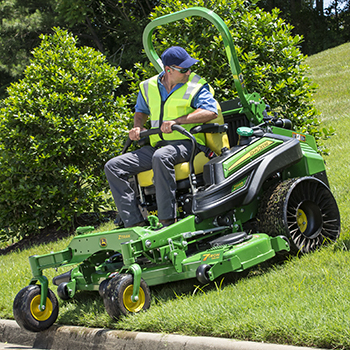 Michelin X Tweel Turf on Z994R
Michelin X Tweel Turf on Z994R
Heavy-duty construction provides the ultimate in performance and reliable operation:
- High-strength poly-resin spokes carry the load.
- Four-hole, heavy-duty steel hub easily bolts onto any Z994R ZTrak Mower.
- Deep, open-tread design provides excellent cleaning and traction.
- Zero degree, high-tensile proprietary carcass provides great lateral stiffness while resisting damage from impact and penetration.
Tires deliver exceptional traction, maneuverability, and reliability
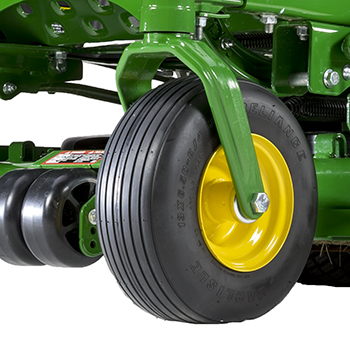 Run flat front caster wheel
Run flat front caster wheel
 Pneumatic rear drive wheel
Pneumatic rear drive wheel
The ZTrak Z994R Mower is equipped with 13x6.5-6 run flat front caster tires that provide:
- Excellent reliability and uptime
- Low center of gravity to increase hillside mowing capability
- Caster wheels and caster wheel towers with sealed bearings for long life and easy steering
- Offset front caster wheels to help improve the inside corner-trim performance and reduce between-blade striping
A choice of rear wheel options is available for factory installation:
- 24x12-12 4 PR pneumatic drive tires in base equipment for excellent traction, flotation, and curb climbing
- 24x12-12 Michelin X Tweel Turf airless radial tire technology option for a smoother ride and more uptime
Michelin, X, and Tweel are trademarks of Michelin North America, Inc.
Powerful 24.7-hp (18.4-kW) diesel engine delivers superior performance and efficiency
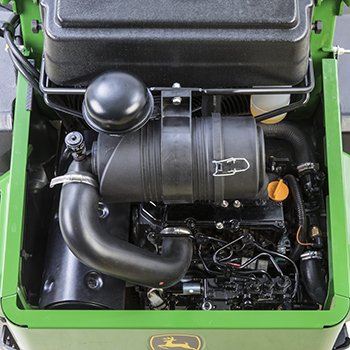 3-cylinder diesel engine
3-cylinder diesel engine
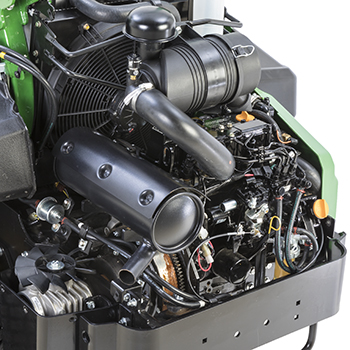 Access to engine service points
Access to engine service points
The Z994R is powered by a 3-cylinder, liquid-cooled diesel engine with gross SAE J1995, PS 24.7 hp (18.4 kW) rated power at 3200 rpm that meets U.S. Environmental Protection Agency (EPA) Final Tier 4 emission standards:
- High-torque, low-emission diesel engine for strong performance in the toughest conditions
- Low vibration and noise levels
- Isolated with rubber mounts for a smoother operator ride
- Superior fuel economy
- High torque reserve for plenty of power and performance
Key features of the engine include:
- Economical, cast-in block cylinder design provides good cooling and long life.
- Liquid-cooled design provides more consistent operating temperatures than air-cooled.
- Fuel filter with replaceable element is provided.
- Indirect fuel injection uses a pre-combustion chamber to give the engine smooth and quiet operation.
- Full-pressure lubrication with full-flow filter lengthens engine life.
- Engine wear reduced by ensuring proper lubrication, even when operating on hillsides or uneven terrain.
- Oil filter helps keep oil clean for increased engine life.
- Aluminum alloy pistons with built-in steel struts are lightweight to reduce connection rod bearing loads and provide good heat-transfer characteristics.
- Design permits tighter tolerances and neutralizes expansion of the piston, thereby reducing blow-by fuel and noise from the piston slap.
- Higher top rings on the piston and a thinner head gasket greatly reduce the volume of unburned waste and increase combustion efficiency.
- Timing gears and injector drive gears utilize helical profile gears to help lower engine noise.
- Gear teeth have a ''roll-off'' profile, giving almost no clash, no noise, and no backlash.
- Glow plugs provide quick starts in temperatures down to -18°C (0°F)
- Key start and shutoff eliminates fuel shut-off knob; electric solenoid shuts fuel supply off immediately when key is turned off.
Air cleaner with secondary safety element and restriction indicator
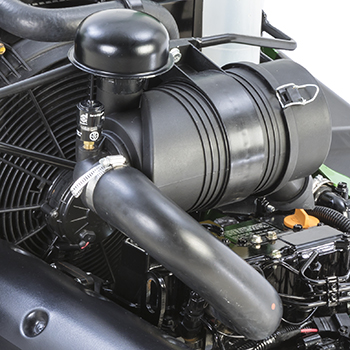 Heavy-duty air cleaner
Heavy-duty air cleaner
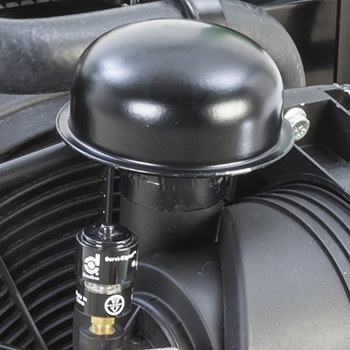 Air cleaner restriction indicator
Air cleaner restriction indicator
- Dual-element, dry-type air cleaner with safety element and air service indicator
- Dual-element design for added engine protection and easy service
- Completely sealed for effective cleaning
- Ninety to 95 percent of dirt ejected before it reaches the paper element
- Air cleaner restriction indicator to let operator know when the filter needs servicing
Radiator
 Radiator cover
Radiator cover
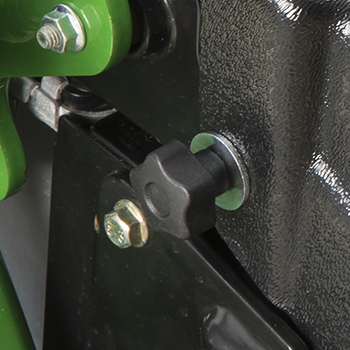 Radiator cover knob
Radiator cover knob
A sealed radiator compartment controls trash and debris. A cover is provided over the radiator, and a cooling fan area controls the flow of air.
Knobs on both ends of the cover hold it in place.
 Radiator shown with debris screen removed
Radiator shown with debris screen removed
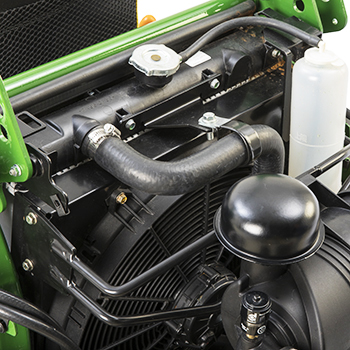 Radiator and electric cooling fan
Radiator and electric cooling fan
An automotive-type radiator, coolant reservoir, and electric cooling fan are provided to remove heat from the engine coolant:
- The cooling fan is thermostatically controlled so it only runs when necessary.
- See-through coolant recovery tank permits the operator to check the coolant level without removing the radiator cap.
 Radiator debris screen
Radiator debris screen
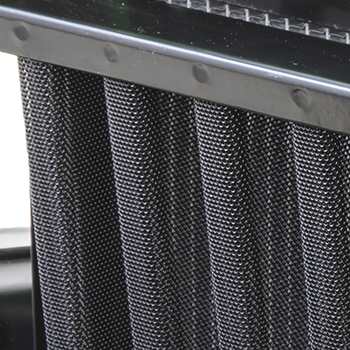 Close-up of radiator debris screen
Close-up of radiator debris screen
A debris screen with a corrugated shape to give a large surface area covers the intake air side of the radiator to keep the radiator fins clean.
The debris screen can be easily removed for cleaning, if desired, and also for access to the radiator fins.
Fuel tank
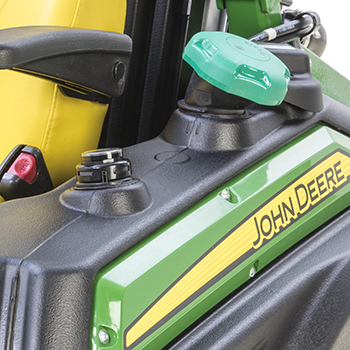 Fuel tank and angled fuel filler cap
Fuel tank and angled fuel filler cap
 Diesel fuel cap and fuel gauge
Diesel fuel cap and fuel gauge
The Z994R Diesel ZTrak™ Mower is equipped with a single 11.5-U.S. gal. (43.5-L) fuel tank that provides enough capacity to allow mowing for a full day without refueling:
- Large, angled filler neck makes for easier refueling
- Fuel cap tether is provided to secure the filler cap while refueling
- Fuel gauge is provided as standard equipment
NOTE: The fuel fill level is 1 in. (25 mm) below the bottom of the filler neck.
Gearbox cooling fins and fan
 Cooling fins and fan for right-angle gearbox
Cooling fins and fan for right-angle gearbox
A right-angle gearbox is used to convert power from the horizontal shaft diesel engine to vertical shaft power to operate the vehicle transmission and the mower power-take off clutch. Cooling for the gearbox is provided by fins on the gearbox housing and a fan.
Durable pump and wheel motor hydrostatic drive delivers speeds up to 11.4 mph (18.3 km/h)
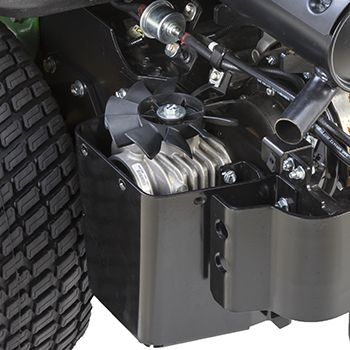 Right angle gearbox with cooling fins and fan
Right angle gearbox with cooling fins and fan
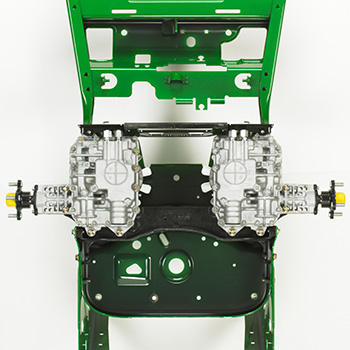 Illustration of unitized pump and wheel motor drives
Illustration of unitized pump and wheel motor drives
A right-angle gearbox is used to convert power from the horizontal shaft diesel engine to vertical shaft power to operate the vehicle transmission. Cooling for the gearbox is provided by fins on the gearbox housing and a fan.
The hydrostatic drive included with the Z994R features two 13-cc (0.8-cu in.) unitized hydraulic pumps combined with commercial-grade, heavy-duty, 13-cc (0.8-cu in.) wheel motors into a single unit. The drive units feature cross porting, where the hydraulic fluid from the side doing the least work is filtered and then fed into the input of the side doing the most work. This ensures that the coolest fluid is going into the side working the hardest in order to provide the best performance during extended hillside operation in the same direction.
One pump and motor drive assembly for each wheel provides the following benefits:
- Exceptional cooling, even in high-load conditions
- Easy-to-check level and refill hydraulic oil
- Opens up access under the seat
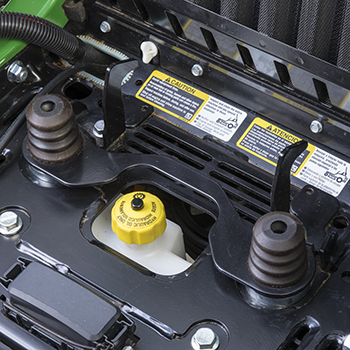 Transmission fluid tank fill cap
Transmission fluid tank fill cap
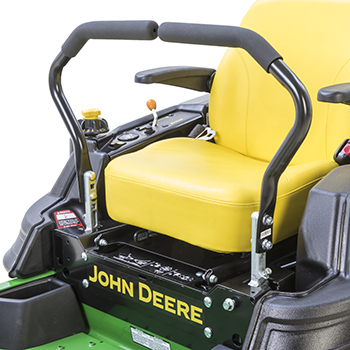 Motion-control levers (shown in operating position)
Motion-control levers (shown in operating position)
One transmission oil reservoir is used for both of the unitized transmissions.
Motion control levers are designed for operator comfort and ease of controlling vehicle speed and direction.
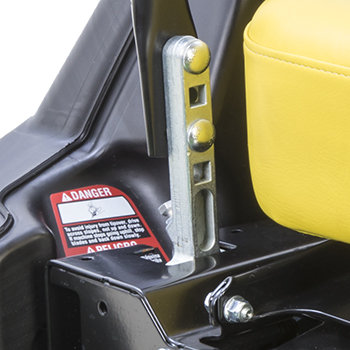 Motion-control lever height adjustment bolts
Motion-control lever height adjustment bolts
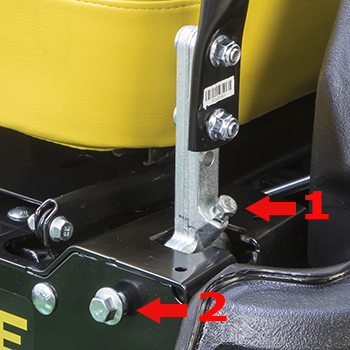 Motion-control lever gap (1) and tracking (2) adjustments
Motion-control lever gap (1) and tracking (2) adjustments
Motion-control lever adjustments include:
- Two height positions to suit the operator.
- Control lever fore/aft position to suit operator size and preference.
- Slots in control levers allow forward/rearward adjustment of control arms when the bolts are loose.
- Gap between the control levers adjustment (1).
- From-the-seat tracking adjustment (2), operators can mow straight and produce professional striping results.
Exceptional operator comfort begins with a high-quality seat and suspension
 High back suspension seat
High back suspension seat
 Seat and operator station
Seat and operator station
Operator comfort was a primary focus in the design of the Z994R:
- Large, open operator station and foot platform with plenty of legroom and room for multiple foot positions
- A choice of seat and suspension options to suit the operator and operating conditions
- Instruments, controls, and storage areas that are easy to see and use
- Three-position rollover protective structure (ROPS) and retractable seat belt for operator safety and convenience
Two seat choices offer exceptional operator comfort
Two seating options are available:
- Fully adjustable seat with adjustable armrests and ComfortGlide fore/aft suspension
- Deluxe comfort seat with adjustable armrests, ComfortGlide™ fore/aft suspension, and rubber cushioning springs
All seat options include:
- Factory installation
- Thick seat cushion for lasting comfort, even after a full day of use
- Retractable seatbelt for convenience and ease of use
- Springs to isolate the seat base for increased ride comfort
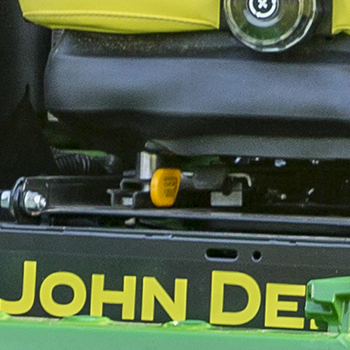 ComfortGlide suspension with fore/aft control
ComfortGlide suspension with fore/aft control
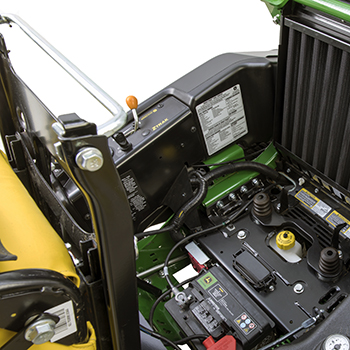 Seat easily raised with spring-loaded latch
Seat easily raised with spring-loaded latch
- ComfortGlide fore/aft suspension for superior ride comfort over uneven areas
- Seat can travel up to 2 in. (50.8 mm) fore and aft to absorb bumps for a significant enhancement to ride comfort
- Ability to easily lock out if desired by the operator
- One lever for three functions
- Slide seat forward and back 3 in. (7.6 cm)
- Activate ComfortGlide fore/aft seat suspension
- Lock-out ComfortGlide fore/aft seat suspension
A spring-type locking mechanism holds the seat securely down in the operating position for operator comfort and safety, but allows quick release for tilting the seat up:
- For protection from the elements
- For access to the transmission fluid reserve tank, battery, etc.
1. Fully adjustable seat with 24-in. (61-cm) high back, armrests and ComfortGlide fore/aft suspension
 Fully adjustable suspension seat with armrests and 24-in. (61-cm) high back
Fully adjustable suspension seat with armrests and 24-in. (61-cm) high back
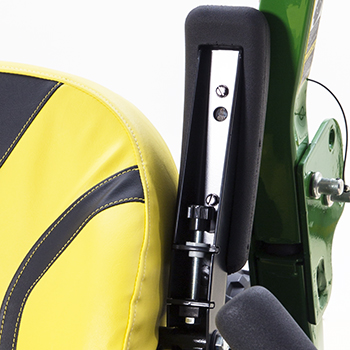 Armrest adjustment
Armrest adjustment
The fully adjustable, 24-in. (61-cm) high-back, mechanical suspension seat with adjustable armrests includes:
- Adjustable armrests that can also be raised for operator convenience
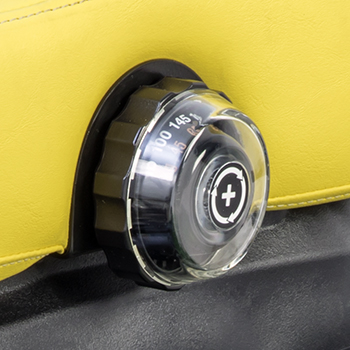 Mechanical suspension seat adjustment
Mechanical suspension seat adjustment
 Lumbar adjustment lever
Lumbar adjustment lever
- Suspension seat control dial for easy adjustment of suspension to suit the operator
- Adjustable lumbar support for operator preference
- Lumbar adjustment gives extra operator comfort
- Adjustment is especially helpful when operating the vehicle for extended periods of time
- Vibration reduction
- Seat back-angle adjustment to maximize operator comfort by using a convenient lever on the side of the seat
2. Deluxe comfort seat with adjustable armrests, ComfortGlide fore/aft suspension, platform isolation, and rubber cushioning springs
 Deluxe comfort seat with armrests and isolation
Deluxe comfort seat with armrests and isolation
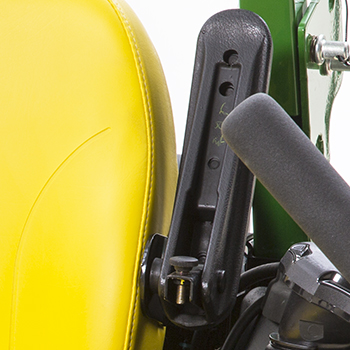 Armrest raised to show adjustment feature
Armrest raised to show adjustment feature
The two-piece, 24-in. (61-cm) deluxe comfort high-back seat has a thick seat cushion for lasting comfort, even after a full day of use:
- Adjustable armrests provide good comfort for the operator.
Armrests can be raised for operator convenience or for making height adjustments for optimum comfort.
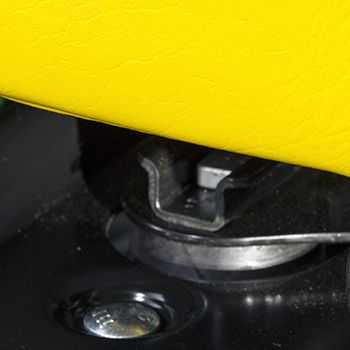 Rubber isolation mount
Rubber isolation mount
A rubber isolation package with four rubber mounts reduces vibration for a more comfortable ride:
- Provides a good option for operators who do not require the more premium, fully adjustable, mechanical suspension-seat option
 Rubber springs
Rubber springs
Two 3-in. (7.6-cm) rubber springs under the seat give a more comfortable ride, especially when traveling over rougher areas.
Foot pegs
 Foot pegs available standard on R-spec Z900’s
Foot pegs available standard on R-spec Z900’s
Foot pegs help provide the operator with a comfortable foot placement.
- Location and angle of foot pegs can be adjusted for individual operator comfort.
Foot platform isolators
 Foot platform isolators
Foot platform isolators
Foot platform isolators provide the operator with added comfort.
- Vibration to the legs and feet is reduced.
Onboard storage and cup holder
 Onboard storage compartment
Onboard storage compartment
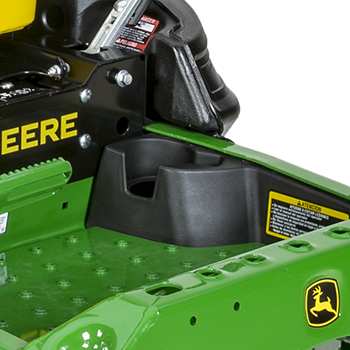 Cup holder
Cup holder
A convenient storage compartment and cup holder are available within easy reach of the operator.
Instruments and controls are easy to find and use
The contoured dash has clean, attractive styling:
- Controls are located on the right instrument panel for convenience
- Color coded and labeled for easy identification by the operator
- Controls are logically placed and easy to reach on the right-hand control panel
- Functional design of the controls provides good appearance and a comfortable feel
Right-hand control panel
 Instrument panel
Instrument panel
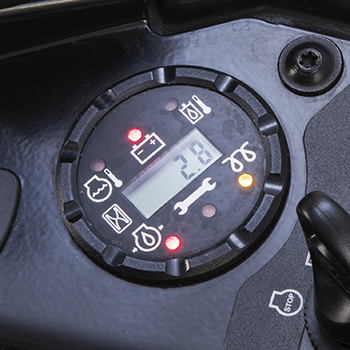 Hour meter, monitoring, and diagnostic display
Hour meter, monitoring, and diagnostic display
Controls are grouped on the right console, providing one central location for key switch, engine speed control, power take-off (PTO) engagement, height-of-cut adjustment, hour meter, and engine diagnostics.
The comprehensive display tells when oil changes and other maintenance should be performed, monitors vehicle function, and helps diagnose common downtime issues:
- A service reminder feature will indicate that a general lubrication or mower/engine service interval has been reached.
- When service is required, arrows will periodically flash for two hours.
- Other features include:
- Hour meter
- Engine overheat warning light
- Battery/alternator warning light
- High transmission oil temperature warning light
- Glow plug on indicator light
- Maintenance needed indicator light
- Low engine oil pressure warning light
Foot pedal Brake & Go starting system and mower lift
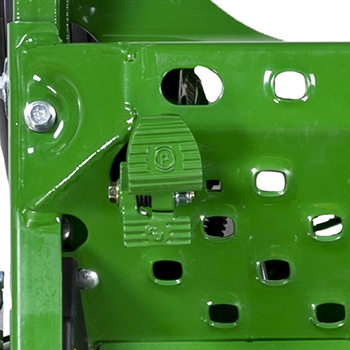 Brake & Go pedal
Brake & Go pedal
 Mower lift pedal
Mower lift pedal
The Brake & Go starting system is a John Deere exclusive. This feature makes the starting process easier:
- The Brake & Go starting system is easy to understand and use.
- To start the machine, the parking brake must be engaged.
- It does not matter whether the PTO switch is on or off, nor does it matter if the control levers are pulled in or extended out.
- As long as the parking brake is engaged, the machine will start. When the parking brake is applied, the control levers cannot be moved.
- Park brake engagement returns motion-control levers to the neutral position.
A foot pedal is used to raise the mower deck to adjust cut height or lock the mower deck in the transport position:
- A foot pedal is easier for many operators to use than a hand lever.
- Adjustable spring assist allows fine-tuning lift effort to the mower and the operator.
Motion-control levers
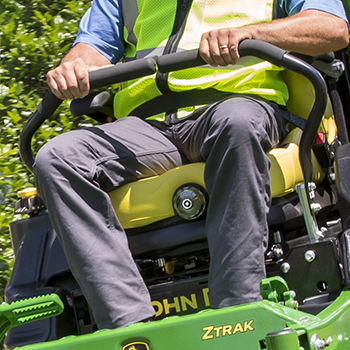 Motion-control levers in use
Motion-control levers in use
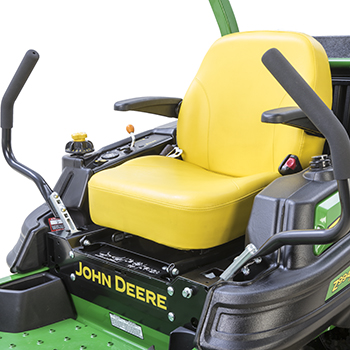 Motion-control levers in park position
Motion-control levers in park position
Two hydrostatic control levers are designed for operator comfort and control:
- Allow the operator to select the ground speed and direction simply by moving levers forward or reverse
- Positive neutral lock position for levers provides added safety
The wide-bend, large-diameter steering levers swing out easily for entry and exit from the operator platform.
Motion-control lever and tracking adjustments
 Motion-control lever height and fore/aft adjustment bolts
Motion-control lever height and fore/aft adjustment bolts
 Motion-control lever gap (1) and tracking (2) adjustments
Motion-control lever gap (1) and tracking (2) adjustments
Motion-control lever adjustments include:
- Two height positions to suit the operator.
- Control lever fore/aft position to suit operator size and preference.
- Slots in control levers allow forward/rearward adjustment of control arms when the bolts are loose.
- Gap between the control levers adjustment (1).
- From-the-seat tracking adjustment (2), operators can mow straight and produce professional striping results.
Cut-height adjustment
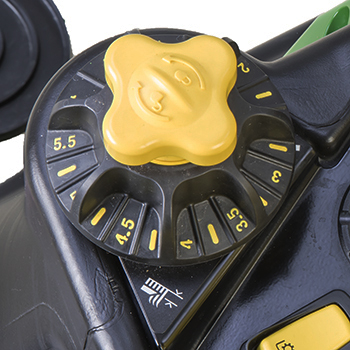 Mower deck height adjustment knob
Mower deck height adjustment knob
 Transport lock knob
Transport lock knob
An easy-to-use height-of-cut adjustment lift system allows the operator to quickly adjust deck height for different mowing applications as well as transport:
- An easy-to-use cutting-height lift system allows the operator to adjust the mower deck height with no tools and minimal effort.
- The easy-to-grip knob allows operators to dial in the desired height of cut (HOC).
- Cutting height can be adjusted from approximately 1 in. to 5.5 in. (2.5 cm to 14 cm).
- Rotate the knob to adjust from 1 in. to 5.5 in. (2.5 cm to 14 cm) in 0.25-in. (0.64 cm) increments.
- Each increment on the knob adjusts the HOC approximately 0.25 in. (0.64 cm).
- The deck can also be raised and locked in a transport position to provide maximum ground clearance when moving the machine from one area to another.
The transport lock function allows the deck to be locked in the transport position and returned to the previous HOC.
- Use the foot-lift pedal to lift the deck, then engage the transport lock.
- To unlock and lower the deck, simply pull up on the transport unlock knob, adjust the dial, and release the deck lift assist pedal to lower the deck to the chosen height.
This design increases productivity by allowing operators to change the cutting height without having to leave the seat.
Thoughtful designs and high-quality controls promote safe operation
Folding rollover protective structure (ROPS)
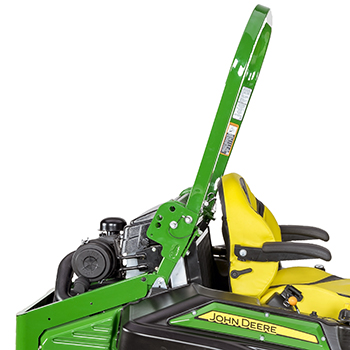 ROPS up position
ROPS up position
 ROPS midway position
ROPS midway position
The Z994 ZTrak™ Mower is equipped with a two-post folding ROPS and a retractable seat belt. The folding ROPS enhances operator safety and provides ample clearance when storing the mower in garages or sheds:
- ISO21299 certification
The ROPS system can be repositioned without the use of tools. Under normal operation, the ROPS should be in the up position.
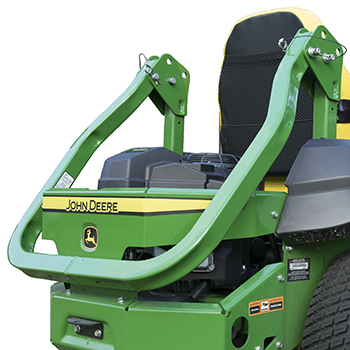 ROPS in the down position (similar vehicle shown)
ROPS in the down position (similar vehicle shown)
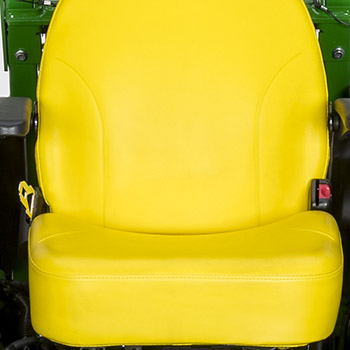 Retractable seat belt
Retractable seat belt
If operating in low clearance areas, the ROPS can be folded and secured out of the way. It can also be positioned halfway down to accommodate machines equipped with a material collection system.
A retractable seatbelt is provided for operator convenience and safety.
Safety interlock systems
 Brake & Go pedal
Brake & Go pedal
 Motion-control levers (shown in operating position)
Motion-control levers (shown in operating position)
The Brake & Go starting system is a John Deere exclusive. This feature makes the starting process easier:
- The Brake & Go starting system is easy to understand and use.
- To start the machine, the parking brake must be engaged.
- It does not matter whether the power take-off (PTO) switch is on or off, nor does it matter if the control levers are pulled in or extended out.
- As long as the parking brake is engaged, the machine will start. When the parking brake is applied, the control levers cannot be moved.
- Brake & Go operator-presence system returns levers to the neutral position when the brake pedal is actively engaged.
Mower deck safety
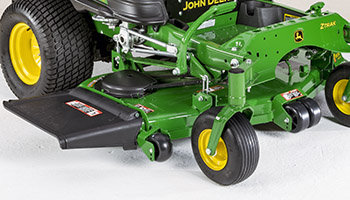 60-in. (152-cm) Mower Deck
60-in. (152-cm) Mower Deck
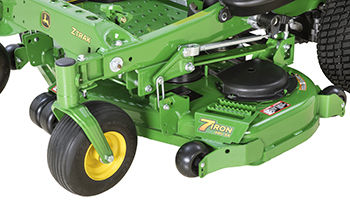 54-in. (137-cm) Mower Deck
54-in. (137-cm) Mower Deck
Mower safety features include:
- A high-quality deflector that meets applicable safety standards and disperses cut grass
- Spindle-sheave shielding that protects and is easy to remove without tools for cleaning and service
- A substantial welded-on metal step on the mower deck for safer operator entry and exit from the machine
Mower decks are safety certified
Mowers decks are evaluated by the manufacturer (John Deere Turf Care) and conform to American Nation Standards Institute (ANSI) B71.4 2004 safety certification specifications for commercial turf care equipment.
Serviceability features give convenience and maximize uptime
 3-cylinder diesel engine
3-cylinder diesel engine
 Access to engine service points
Access to engine service points
Frequently accessed service areas such as the air cleaner, radiator screen, and oil check and fill points can be easily accessed from the open engine compartment.
An easy-to-remove rear engine service panel allows access to all engine service points for scheduled service or other maintenance work.
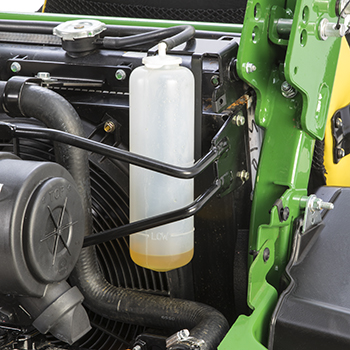 Radiator coolant reservoir
Radiator coolant reservoir
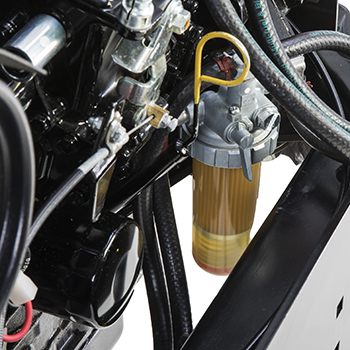 Engine oil filter, dipstick, and fuel filter/water separator
Engine oil filter, dipstick, and fuel filter/water separator
The design of the Z994R makes service components like the engine oil dipstick, oil filter, and fuel filter/water separator easy to see and access:
- Large radiator coolant reservoir and fuel filter/separator reduce service requirements and increase uptime.
- A convenient fuel shutoff is provided on the filter/separator.
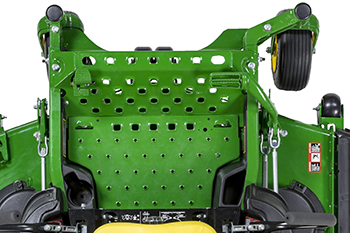 Removable floor panel
Removable floor panel
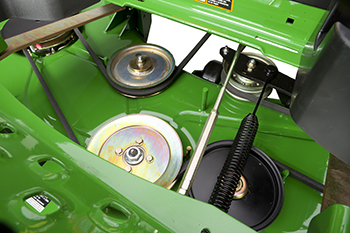 Floor panel removed for mower access (similar Z970R shown)
Floor panel removed for mower access (similar Z970R shown)
The floor panel is easily removed, without tools, to give access to the top of the mower deck for cleaning and service.
All mower deck blade spindle grease fittings can be accessed from the top of the mower deck.
Battery and transmission fluid reservoir access
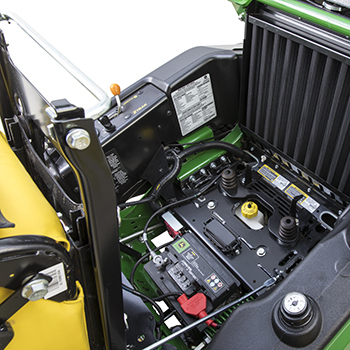 Flip-up seat
Flip-up seat
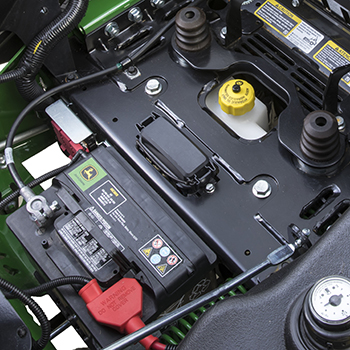 Service access with seat in raised position
Service access with seat in raised position
The seat is locked down for operator comfort and safety, but the spring latch system is easily released to raise the seat to protect it from the elements and give access to the battery, transmission fluid reservoir, etc.
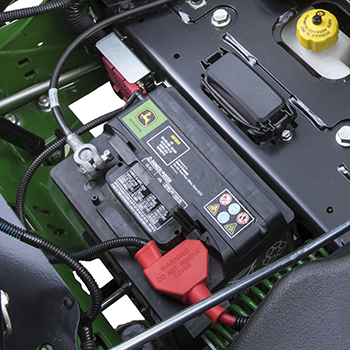 Battery
Battery
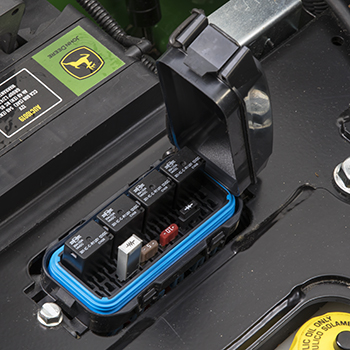 Sealed fuse and relay box
Sealed fuse and relay box
- Maintenance free, 600 cold-cranking amp (CCA) battery is provided for fast, reliable engine starts.
- Electrical box is sealed to keep dirt and moisture out for reliability and ease of service.
Motion-control lever and tracking adjustments
 Motion-control lever two-position height adjustment
Motion-control lever two-position height adjustment
 Adjustments for fore-aft position (1) and tracking (2)
Adjustments for fore-aft position (1) and tracking (2)
Motion-control lever adjustments include:
- Two height positions to suit the operator
- Control lever fore/aft position to suit operator size and preference
- Slots in control levers allow forward/rearward adjustment of control arms when the bolts are loose.
- Gap between the control levers adjustment (1)
- From-the-seat tracking adjustment (2) so operators can mow straight and produce professional striping results
Service information and diagnostics
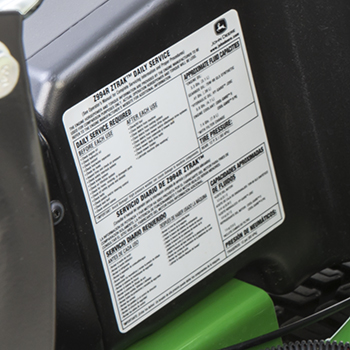 Service information label
Service information label
 Digital multi-function display
Digital multi-function display
A digital multifunction display shows the number of hours the machine is run when the key switch is in the on position. It only counts the hours the engine is actually running. Monitoring systems to notify operators of machine status and quickly diagnose common downtime issues include:
- Glow plug monitor
- Maintenance required notification
- Low oil pressure
- Hour meter
- Coolant overheat notification
- Battery charging system
- High engine oil temperature
Optional service jack kit and jack
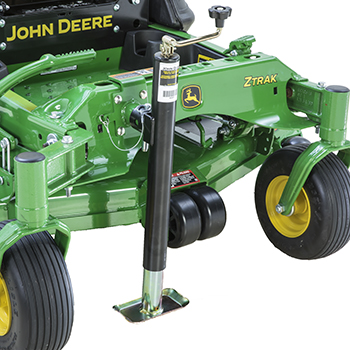 Jack kit and jack installed
Jack kit and jack installed
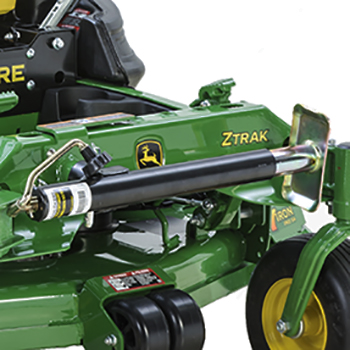 Jack in storage position
Jack in storage position
The Z994R front frame member is pre-drilled to accept the optional jack kit and jack:
- The jack makes servicing the underside of the mower deck safer and easier.
- Placed in the storage position, the jack can be carried on the machine, always available for use.
- The jack will need to be removed when using front ballast that is required for a rear material collection system.
Three-year, 1500-hour bumper-to-bumper warranty
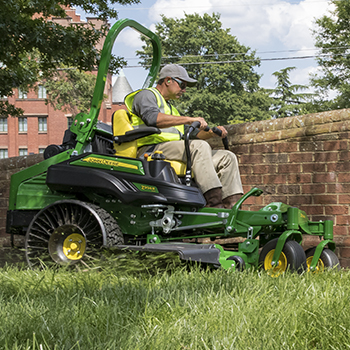 Z994R ZTrak™ Mower
Z994R ZTrak™ Mower
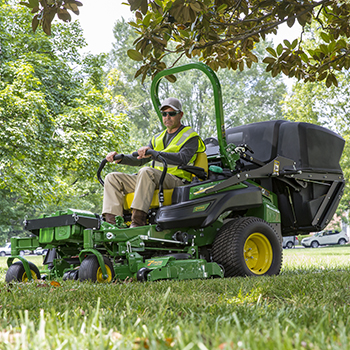 Z994R ZTrak Mower
Z994R ZTrak Mower
An exclusive two-year, unlimited hour/three-year, 1500-hour (whichever comes first) bumper-to-bumper warranty is standard on the Z994R. The warranty is best in the industry and puts John Deere at the forefront of commercial mowing. It is also hassle free, with one company handling all of the paperwork.
NOTE: The warranty covers 36 months or 1500 hours, whichever comes first. For the first 24 months, there is no hour limitation.
Four mower deck options give superior performance in every application
 Z994R with fully-adjustable suspension seat option and 72-in. (183-cm) mower deck
Z994R with fully-adjustable suspension seat option and 72-in. (183-cm) mower deck
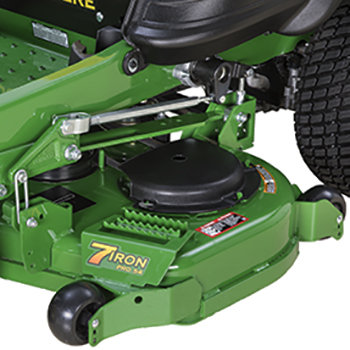 Reinforcement welded on left end of mower
Reinforcement welded on left end of mower
There are four mower-deck options available for the Z994R Diesel ZTrak™ Mower:
- The 54-in. (137-cm) 7-Iron™ PRO Side-Discharge Mower Deck is suited to a variety of mowing jobs, including trimming and grooming.
- The 60-in. (152-cm) 7-Iron PRO Side-Discharge Mower Deck is suited to a variety of mowing jobs, including trimming and grooming.
- The 60-in. (152-cm) 7-Iron PRO Mulch On Demand™ Mower Deck can be converted from a wide-open, side-discharge mode to a fully chambered mulching mode with a single move of a lever.
- The 72-in. (183-cm) 7-Iron PRO Side-Discharge Mower Deck is suited to a variety of mowing jobs, including trimming and grooming.
54-in. (137-cm) 7-Iron PRO Mower Deck
 Similar 60-in. (152-cm) 7-Iron PRO Mower Deck shown
Similar 60-in. (152-cm) 7-Iron PRO Mower Deck shown
Features include:
- Higher blade tip speed of 18,000 fpm (5486 m/min) gives more blade strikes per distance of forward travel.
- The front baffle is designed to better manage airflow and control clippings.
- Spindle-pocket reinforcement provides even greater structural durability.
- A raised discharge chute allows for even clipping distribution.
- Thick, 7-gauge, 0.179-in. (4.55-mm) steel construction gives commercial durability.
- The three-spindle design provides a smooth, even cut.
- A plastic discharge deflector reduces damage to foliage and resists bending.
- The formed, steel-deck design is stamped from a single sheet of steel to eliminate corners where grass can collect.
- The deep deck gives increased vacuum action that reduces dropped clippings.
- The belt drive efficiently transfers power from gearbox to spindles.
- Spindle grease fittings are on top for easy access.
- Quick-change cutting-height adjustment is easy to use.
- Blade overlap of 1.57 in. (40 mm) reduces the number of missed grass blades.
- A mulching attachment is available.
- The Power Flow™ rear material collection system is available.
60-in. (152-cm) 7-Iron PRO Mower Deck
 Similar 60-in. (152-cm) 7-Iron PRO Mower Deck shown
Similar 60-in. (152-cm) 7-Iron PRO Mower Deck shown
Features include:
- Higher blade tip speed of 18,000 fpm (5486 m/min) gives more blade strikes per distance of forward travel.
- The front baffle is designed to better manage airflow and control clippings.
- Spindle-pocket reinforcement provides even greater structural durability.
- A raised discharge chute allows for even clipping distribution.
- Thick, 7-gauge, 0.179-in. (4.55-mm) steel construction gives commercial durability.
- The three-spindle design provides a smooth, even cut.
- A plastic discharge deflector reduces damage to foliage and resists bending.
- The formed, steel-deck design is stamped from a single sheet of steel to eliminate corners where grass can collect.
- The deep deck gives increased vacuum action that reduces dropped clippings.
- The belt drive efficiently transfers power from gearbox to spindles.
- Spindle grease fittings are on top for easy access.
- Quick-change cutting-height adjustment is easy to use.
- Blade overlap of 1.57 in. (40 mm) reduces the number of missed grass blades.
- A mulching attachment is available.
- The Power Flow rear material collection system is available.
Mower deck specifications
|
54-in. (137-cm) |
60-in. (152-cm) |
60-in. (152-cm) |
72-in. (183-cm) Side-Discharge |
Mower type |
7-Iron PRO - stamped deck |
7-Iron PRO - stamped deck |
7-Iron PRO - stamped deck |
7-Iron PRO - stamped deck |
Mower compatibility: |
|
|
|
|
Discharge |
Side |
Side |
Side |
Side |
Mulching |
Optional field-installed kit |
Optional field-installed kit |
Standard Mulch On Demand included |
Optional field-installed kit |
Cut-height |
1.5-5 in. (3.8-12.7 cm) in 0.25-in. (6.35 mm) increments |
1.5-5 in. (3.8-12.7 cm) in 0.25-in. (6.35 mm) increments |
1.5-5 in. (3.8-12.7 cm) in 0.25-in. (6.35 mm) increments |
1.5-5 in. (3.8-12.7 cm) in 0.25-in. (6.35 mm) increments |
Cutting width |
54 in. (137 cm) |
60 in. (152 cm) |
60 in. (152 cm) |
72 in. (183 cm) |
Height-of-cut |
Turning knob with foot pedal lift |
Turning knob with foot pedal lift |
Turning knob with foot pedal lift |
Turning knob with foot pedal lift |
High lift blades: |
|
|
|
|
Blade length |
19.1 in. (48.5 cm) |
21 in. (53 cm) |
21 in. (53 cm) |
25 in. (63 cm) |
Blade width |
3 in. (7.6 cm) |
3 in. (7.6 cm) |
3 in. (7.6 cm) |
3 in. (7.6 cm) |
Blade thickness |
0.25 in. (6.35 mm) |
0.25 in. (6.35 mm) |
0.25 in. (6.35 mm) |
0.25 in. (6.35 mm) |
Blade tip speed |
18,000 fpm (5486 m/min) |
18,000 fpm (5486 m/min) |
18,000 fpm (5486 m/min) |
18,000 fpm (5486 m/min) |
Number of |
Three |
Three |
Three |
Three |
Blade spindles: |
|
|
|
|
Bearings |
Grade=ABEC-1 |
Grade=ABEC-1 |
Grade=ABEC-1 |
Grade=ABEC-1 |
Spindles |
Cold-forged and heat-treated |
Cold-forged and heat-treated |
Cold-forged and heat-treated |
Cold-forged and heat-treated |
Spindle |
Aluminum |
Aluminum |
Aluminum |
Aluminum |
Wheels: |
|
|
|
|
Front anti-scalp |
Standard |
Standard |
Standard |
Standard |
Rear anti-scalp rollers |
Standard |
Standard |
Standard |
Standard |
Deck construction |
One-piece stamped steel |
One-piece stamped steel |
One-piece stamped steel |
One-piece stamped steel |
Deck thickness |
7-gauge steel, 0.179 in. (4.55 mm) |
7-gauge steel, 0.179 in. (4.55 mm) |
7-gauge steel, 0.179 in. (4.55 mm) |
7-gauge steel, 0.179 in. (4.55 mm) |
Optional three-bag material collection system (MCS)
 Three-bag MCS
Three-bag MCS
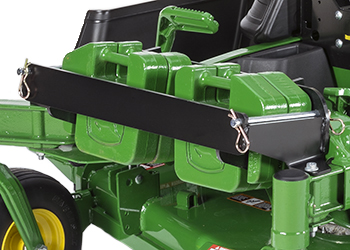 Standard weight bracket and weights, for three-bag MCS
Standard weight bracket and weights, for three-bag MCS
The 14-bu (493-L), three-bag MCS is available for the Z994R with a 54-in. (137-cm) or 60-in. (152-cm) Mower Deck, or a 60-in. (152-cm) Mulch On Demand Mower Deck. Professional landscape contractors can increase productivity by utilizing this durable collection system. This system allows fast, easy grass clipping and leaf collection to give lawns a well-groomed appearance.
Optional Power Flow blower
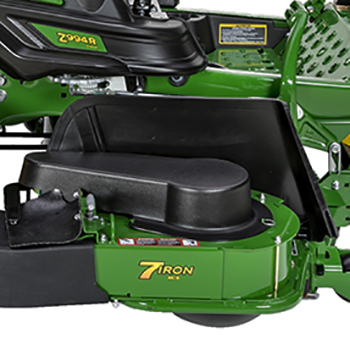 Power Flow blower
Power Flow blower
 Power Flow blower in cleanout position
Power Flow blower in cleanout position
A Power Flow blower is required (ordered separately) for use of a three-bag or dump-from-seat MCS.
The Power Flow blower can be opened for easy and thorough cleanout.
60-in. (152-cm) 7-Iron PRO Mulch On Demand Mower Deck
 60-in. (152-cm) 7-Iron PRO Mulch On Demand Mower Deck (shown on Z997R)
60-in. (152-cm) 7-Iron PRO Mulch On Demand Mower Deck (shown on Z997R)
 Mulch On Demand control lever (shown on Z997R)
Mulch On Demand control lever (shown on Z997R)
Features include:
- The deck can be converted from a wide-open side discharge mode to a fully chambered mulching mode with a single move of a lever.
- Higher blade tip speed of 18,000 fpm (5486 m/min) gives more blade strikes per distance of forward travel.
- The front baffle is designed to better manage airflow and control clippings.
- Spindle-pocket reinforcement provides even greater structural durability.
- A raised discharge chute allows for even clipping distribution.
- Thick, 7-gauge, 0.179-in. (4.55-mm) steel construction gives commercial durability.
- The three-spindle design provides a smooth, even cut.
- A plastic discharge deflector reduces damage to foliage and resists bending.
- The formed, steel-deck design is stamped from a single sheet of steel to eliminate corners where grass can collect.
- The deep deck gives increased vacuum action that reduces dropped clippings.
- The belt drive efficiently transfers power from gearbox to spindles.
- Spindle grease fittings are on top for easy access.
- Quick-change cutting-height adjustment is easy to use.
- Blade overlap of 1.57 in. (40 mm) reduces the number of missed grass blades.
- The mulching attachment is available.
- The Power Flow rear material collection system is available.
72-in. (183-cm) 7-Iron PRO Mower Deck
 Similar 72-in. (183-cm) mower deck shown
Similar 72-in. (183-cm) mower deck shown
Features include:
- Higher blade tip speed of 18,000 fpm (5486 m/min) gives more blade strikes per distance of forward travel.
- The front baffle is designed to better manage airflow and control clippings.
- Spindle-pocket reinforcement provides even greater structural durability.
- A raised discharge chute allows for even clipping distribution.
- Thick, 7-gauge, 0.179-in. (4.55-mm) steel construction gives commercial durability.
- The three-spindle design provides a smooth, even cut.
- A plastic discharge deflector reduces damage to foliage and resists bending.
- The formed, steel-deck design is stamped from a single sheet of steel to eliminate corners where grass can collect.
- The deep deck gives increased vacuum action that reduces dropped clippings.
- The belt drive efficiently transfers power from gearbox to spindles.
- Spindle grease fittings are on top for easy access.
- Quick-change cutting-height adjustment is easy to use.
- Blade overlap of 1.57 in. (40 mm) reduces the number of missed grass blades.
- A mulching attachment is available.
- The Power Flow rear material collection system is available.
Optional dump-from-seat material collection system
 Dump-from-seat MCS
Dump-from-seat MCS
 Standard weight bracket and weights, for dump-from-seat MCS
Standard weight bracket and weights, for dump-from-seat MCS
The durable dump-from-seat MCS for the Z994R ZTrak Mower increases productivity. Professional landscape contractors are able to empty the large, 13-bu (458-L) capacity hopper without leaving the seat. This system allows fast, easy grass clipping and leaf collection to give lawns a well-groomed appearance.
Features
Heavy-duty frame provides strength and durability
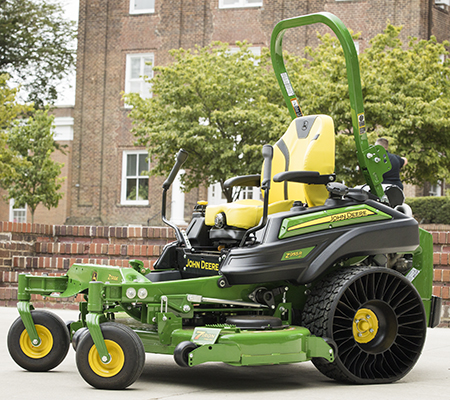 Z955R EFI model shown with optional X® Tweel® Turf airless radial tire technology
Z955R EFI model shown with optional X® Tweel® Turf airless radial tire technology

The durability features of the frame are as follows:
-
Heavy-duty, thick-gauge, steel channel mainframe for strength and durability
-
Cast I-beam caster arms to handle the beating and pounding professional mowers receive
-
Wide-open access for maintenance and cleaning
Two-piece rear bumper provides protection
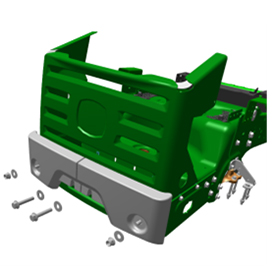 Illustration of ZTrak™ mower rear bumper
Illustration of ZTrak™ mower rear bumper
A steel rear bumper provides protection for the machine. The bumper is made of two pieces, making it easy to remove and install when using a material collection system (MCS).
A rear hitch can be added to the steel bumper for towing purposes. ZTrak E, M, and R Series Mowers can tow up to 400 lb (181.4 kg).
Michelin, X, and Tweel are trademarks of Michelin North America, Inc.
Michelin® X® Tweel® Turf airless radial tire technology for ZTrak™ Mowers eliminates downtime and reduces cost of operation
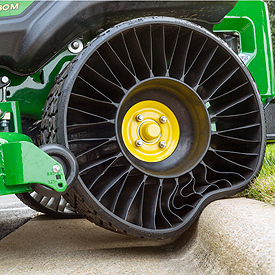 Flat-free rear tire shown on ZTrak Mower
Flat-free rear tire shown on ZTrak Mower
John Deere provides the commercial mower industry with the Michelin X Tweel Turf technology for Commercial ZTrak Mowers:
- 24x12N12 as an ordering option code for ZTrak Gas Mowers with 54 in., 60 in., and 72 in. (137-cm, 152-cm, and 183-cm) Mower Decks
- 24x12N12 is also available as base code equipment for ZTrak Gas Mowers with 54 in., 60 in., and 72 in. (137-cm, 152-cm, and 183-cm) Mower Decks (ordering information available at Configurator on the Tweel model page)
- 24x12N12 as an ordering option code for ZTrak Z994R Diesel with 54 in., 60 in., and 72 in. (137-cm, 152-cm, and 183 cm) Mower Decks
- 26x12N12 as an ordering option code for Z997R Diesel with 60 in. and 72 in. (152-cm and 183-cm) Mower Decks
Michelin is a world leader in tire manufacturing and technology. This airless radial tire solution is an industry first for John Deere, which provides an additional advantage to John Deere customers.
Advantages of the Michelin X Tweel Turf include:
- Mowing performance is improved.
- Rutting is reduced because the Michelin X Tweel Turf has more support across the surface for improved flotation and better ground contact.
- Unique energy transfer within the poly-resin spokes reduces the bounce associated with pneumatic tires.
- Excellent curb climbing is possible due to the Michelin X Tweel Turf construction and flexibility.
- More consistent cut quality is achieved because inconsistent tire pressure is eliminated.
- Uptime is improved.
- The exclusive technology eliminates downtime and associated cost due to flat or damaged tires.
- Punctures and sidewall damage no longer result in downtime.
- Cost of operation is reduced.
- Cost of repairs and maintenance is reduced. One single unit replaces the current tire, wheel, and valve assembly. There is no need for complex tire-mounting equipment.
- No need to spend time checking and optimizing tire pressure.
- The need to purchase and stock plug kits and spare tires is eliminated, particularly for professional landscape contractors and government agencies who normally stock them.
- The tire tread will last up to three times longer than current pneumatic tires because automotive-grade rubber is used for the tread.
 Michelin X Tweel Turf
Michelin X Tweel Turf
 Michelin X Tweel Turf
Michelin X Tweel Turf
Heavy-duty construction provides the ultimate in performance and reliable operation:
- High-strength poly-resin spokes carry the load.
- Four-hole, heavy-duty steel hub for durability.
- Deep, open-tread design provides excellent cleaning and traction.
- Zero degree, high-tensile proprietary carcass provides great lateral stiffness while resisting damage from impact and penetration.
NOTE: In some cases, different size Tweel tires are required depending on the mower deck size.
Tires deliver exceptional traction and maneuverability
 Drive tire
Drive tire
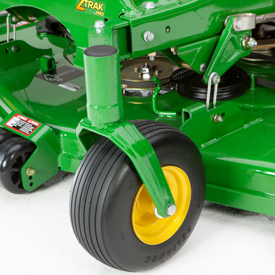 Front caster tire
Front caster tire
The ZTrak R Series Mowers with 48-in. (122-cm) mower decks come with 24x9.5-12 4 PR drive tires. R Series Mowers with 54-in. (133-cm), 60-in. (152-cm) and 72-in. (183-cm) decks come with 24x12-12 4 PR drive tires. All R Series Mowers are equipped with 15x6-6 front flat-free tires for the following:
- Excellent traction, flotation, and curb climbing
- Low center of gravity to increase hillside mowing capability
- Caster wheels and caster wheel towers with sealed bearings for long life and easy steering
- Offset front caster wheels to help improve the inside corner-trim performance and reduce between-blade striping
Michelin, X, and Tweel are trademarks of Michelin North America, Inc.
Powerful 35.0-hp (26.1-kW) commercial-grade engine delivers class-leading performance and efficiency
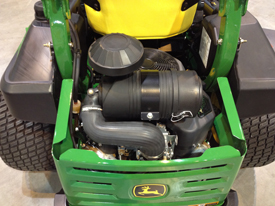 Z970R engine
Z970R engine

The Z970R is powered by an air-cooled, vertical shaft engine:
- 35.0-hp (26.1-kW) gas engine
Engine features include:
- Overhead valve design
- More horsepower and torque per cubic inch of displacement
- Better fuel efficiency
- Full-pressure lubrication with full-flow filter
- Reduces engine wear by ensuring proper lubrication, even when operating on hillsides or uneven terrain
- Oil filter helps keep oil clean for increased engine life
- V-twin big block design
- Vertical shaft
- Easy-access, dual-element air filter with quick-release latch
- 15-amp alternator
- Fuel pump
- Complies with strict Environmental Protection Agency (EPA) and California Air Resources Board (CARB) emission standards without loss of horsepower or torque
- Aluminum block engines
- Effectively dissipate heat
- Lightweight and strong construction
- Extend engine life due to elimination of debilitating engine temperatures
- Air-cooled engine design
Air cleaner filters out dust that can damage an engine
 Engine air cleaner
Engine air cleaner
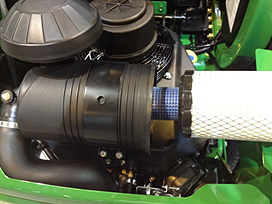 Air cleaner cover removed
Air cleaner cover removed
ZTrak™ Z900 Mowers are equipped with a dual-element, canister-style air filter, easily accessible from the rear of the machine without tools.
- The filtration system pulls clean air from above the engine, in turn filtering out the dust that can damage an engine over time.
- Filters are extremely easy to change when required.
- Pre-cleaner provides more protection against contamination in dusty and dirty applications.
Mow all day on a single tank of fuel with efficient and easy-to-fill fuel tank
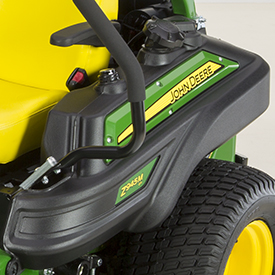 Fuel tank and filler neck
Fuel tank and filler neck
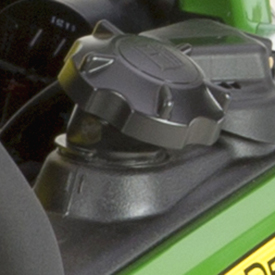 Fuel filler neck
Fuel filler neck
The ZTrak™ Z900 Mowers are equipped with one single-fill, top-draw fuel tank:
- 11.5-U.S. gal. (43.5-L) capacity enables operators to mow all day without refueling.
- The fuel gauge makes it quick and easy to see how much fuel is in the tank.
- Top draw provides added safety.
- A large fuel-filler neck is angled to make it easy for an operator to complete the fueling process.
Under normal conditions, load, and operation, fuel consumption for the Z900 ZTrak Mowers is 1.5 U.S. gph (5.7 L/hr) to 2.2 U.S. gph (8.3 L/hr), depending on the horsepower and conditions.
Durable, hydrostatic drivetrain including cross porting delivers better cooling and provides easy access
 Heavy-duty ground drive
Heavy-duty ground drive
The hydrostatic drive included with the R Series Mowers features two 13-cc (0.8-cu in.) unitized hydraulic pumps combined with commercial-grade, heavy-duty, 13-cc (0.8-cu in.) wheel motors into a single unit. The R Series drive units feature cross porting, where the hydraulic fluid from the side doing the least work is filtered and then fed into the input of the side doing the most work. This ensures that the coolest fluid is going into the side working the hardest in order to provide the best performance during extended hillside operation in the same direction.
One pump and one motor drive each wheel on the ZTrak™ R Series Mowers. This provides several benefits:
- Exceptional cooling in high load conditions
- Easy-to-check level and refill hydraulic oil
- Opens up access under the seat
Two seat choices with ComfortGlide™ fore/aft suspension offer exceptional operator comfort
There are two seating options available for the R Series, all of which are factory installed
- Deluxe comfort seat with armrests and isolation
- Fully adjustable suspension seat with armrests
ComfortGlide fore/aft suspension
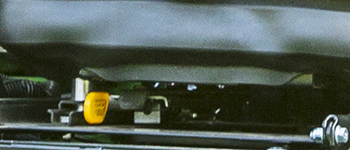 ComfortGlide fore/aft suspension control lever
ComfortGlide fore/aft suspension control lever
Each seat has the ComfortGlide fore/aft suspension system that gives superior ride comfort over uneven areas:
- Seat can travel up to 2 in. (50.8 mm) fore and aft to absorb bumps for a significant enhancement to ride comfort.
- Control lever provides the ability to easily lock out fore/aft suspension movement if desired.
- One lever has three functions:
- Slide seat forward and back 3 in. (10.2 cm) to allow the operator the ability to choose the leg room needed
- Activate ComfortGlide fore/aft seat suspension
- Lock out ComfortGlide fore/aft seat suspension
Deluxe comfort seat with armrests and isolation
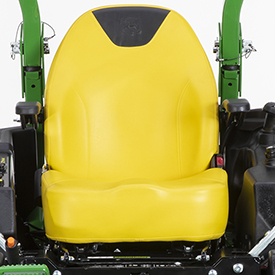 Deluxe comfort seat with armrests and isolation
Deluxe comfort seat with armrests and isolation
 Rubber isolation mount
Rubber isolation mount
The deluxe comfort seat with armrests and isolation is available on the E, M, and R Series:
- Rubber springs are provided to isolate the seat base and to increase ride comfort.
- A convenient seat latch makes it easy to lift the seat.
- Isolation mounting is a good feature to reduce vibration for operators who do not require the fully adjustable suspension seat option.
- Factory installed on Z900s ordered with the deluxe comfort seat with armrests and isolation option.
Fully adjustable suspension seat with armrests
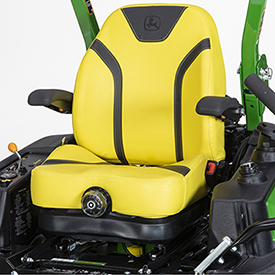 Fully adjustable, mechanical suspension-seat
Fully adjustable, mechanical suspension-seat
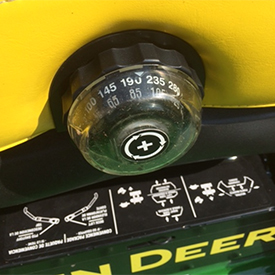 Suspension seat control
Suspension seat control
A fully adjustable suspension seat with armrests option is available on the M and R Series:
- Adjustable back angle is provided for individual operator comfort.
- Adjustable lumbar support helps to suit the needs of the operator.
- A suspension seat control dial gives easy adjustment for operator weight and ride comfort.
- A convenient seat latch provides ease of lifting the seat.
- On Z900s ordered with the fully adjustable suspension seat with armrests option, it is factory installed.
Designed for operator comfort
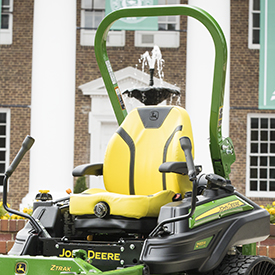 Operator station
Operator station
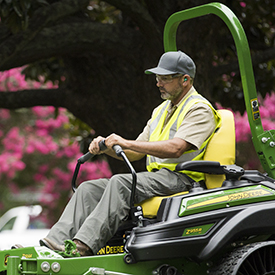 Operator station
Operator station
Two-lever hydrostatic control provides the following:
- The operator can select the ground speed and direction control simply by moving levers forward or reverse.
- Positive neutral lock position for levers provides added safety.
- Brake & Go operator-presence system returns levers to the neutral position when the brake pedal is actively engaged.
- Starting the machines is as easy as starting a car. It no longer matters if the control levers are extended out or pulled in, as long as the parking brake is engaged. Just turn the key and go.
- Wide-bend, large-diameter steering levers swing out easily for entry and exit from the operator platform.
Foot pegs
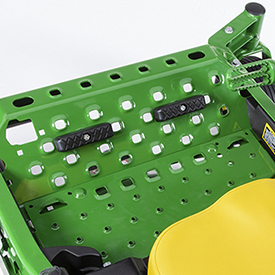 Foot pegs available as standard on R-spec Z900’s
Foot pegs available as standard on R-spec Z900’s
Foot pegs help in providing the operator with a comfortable foot placement:
- Location and angle of foot pegs can be adjusted for individual operator comfort.
Foot platform isolators
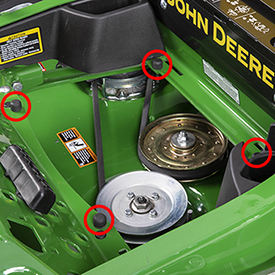 Foot platform isolators
Foot platform isolators
Foot platform isolators provide the operator with added comfort:
- Vibration to the legs and feet is reduced.
Brake & Go starting system
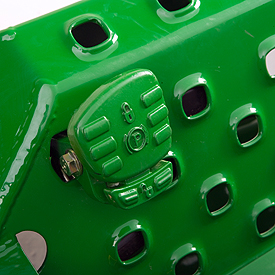 Parking brake pedal (Z900R Series)
Parking brake pedal (Z900R Series)
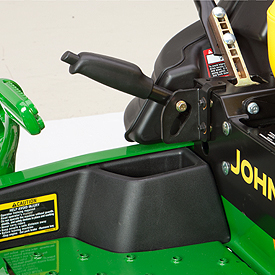 Parking brake lever (Z900 E and M Series)
Parking brake lever (Z900 E and M Series)
The Brake & Go starting system is a John Deere exclusive. This feature makes the starting process on all ZTrak™ mowers easier, while also making it possible to remove two interlock switches from the machine.
The Brake & Go starting procedure helps a novice operator look and feel like a professional. To start the machine, the parking brake must be engaged. It does not matter whether the power take-off (PTO) switch is on or off, nor does it matter if the control levers are pulled in or in the out position.
As long as the parking brake is engaged, the machine will start. When the parking brake is applied, the control levers cannot be moved to the forward or reverse positions.
Adjustable levers
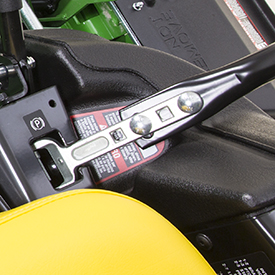 Adjustable levers
Adjustable levers
The motion control levers have two height positions and can also be adjusted forward or rearward within the slotted holes. The levers should be adjusted so the operator can achieve a full range of control operation comfortably.
Tracking adjustment
 Tracking adjustment
Tracking adjustment
The easy-to-turn (from-the-seat) tracking adjustment allows operators to keep their mowers straight and able to produce professional striping results.
Onboard storage and cup holder
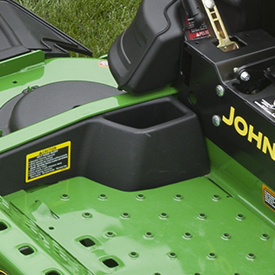 Onboard storage
Onboard storage
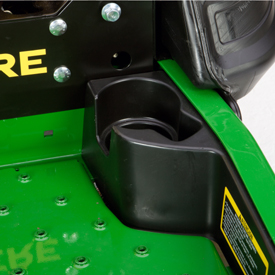 Cup holder
Cup holder
Several storage areas are provided on the ZTrak machines. A convenient cup holder is also available.
Right-hand control panel
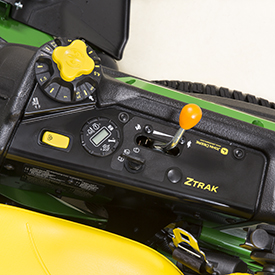 Right-hand control panel
Right-hand control panel
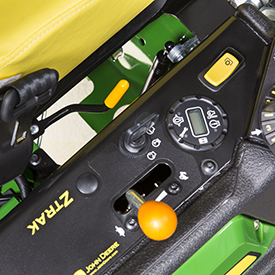 Right-hand control panel
Right-hand control panel
The controls are grouped together on the right console, providing one central location for key switch, throttle, PTO engagement, height-of-cut, diagnostics, and hour meter:
- Rocker-type PTO switch
- Height-of-cut knob with transport lock
- Key switch
- Hourmeter
- Throttle
- Separate choke control
- Easy choke operation yields less fouling of plugs
- No choke required for the electronic fuel injection (EFI) models
Easy-to-operate height-of-cut adjustment enables on-the-go changes
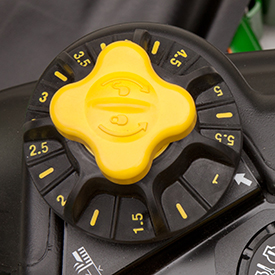 Mower deck height adjustment knob
Mower deck height adjustment knob
An easy-to-use cutting-height lift system allows the operator to adjust the mower deck height with no tools and minimal effort. The easy-to-grip knob allows operators to dial in the desired height of cut (HOC).
Cutting height can be adjusted from approximately 1 in. to 5.5 in. (2.5 cm to 14 cm). Each increment on the knob adjusts the HOC approximately 0.25 in. (0.64 cm). The deck can also be raised and locked in a transport position to provide maximum ground clearance when moving the machine from one area to another.
The transport lock function allows the deck to be returned to the previous HOC after being in the transport position:
- Use the foot-lift pedal to lift the deck and engage the transport lock.
- Rotate the knob to adjust from 1 in. to 5.5 in. (2.5 cm to 14 cm) in 0.25-in. (0.64 cm) increments.
This design increases productivity by allowing operators to change the cutting height without having to leave the seat.
Standard comfort and convenience allows for easy deck height adjustment and power take-off (PTO) shutoff
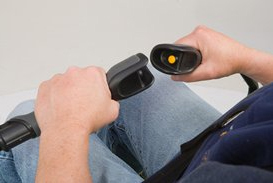 Comfort and convenience handles
Comfort and convenience handles
The comfort and convenience package combines large, ergonomically angled control levers with specially padded grips to provide unmatched comfort and reduced fatigue:
-
Keeps hands on the control sticks to minimize equipment damage and make them more comfortable over long operating days.
The control levers have built-in electronic controls to raise or lower the mower deck or disengage the mower blades.
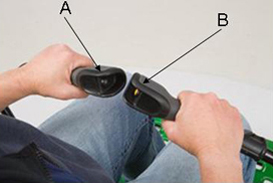 Control buttons
Control buttons
The push button (A) on the left motion control lever raises the mower deck.
The push button (B) on the right-hand control lever shuts off the PTO.
Once the PTO has been shut off using the button, the PTO switch must be pushed down and pulled up again to engage the PTO.
Mower is easy to service with many accessible components
 Z955R EFI left front view
Z955R EFI left front view
The design of the Z900 Series makes many service components reachable and easily accessible from the ground.
- Large, open engine compartment at the rear of the machine provides convenient servicing and ensures the engine heat is directed away from the operator.
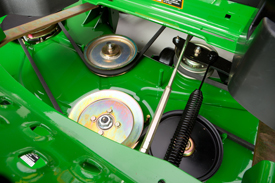 Flip-up foot panel
Flip-up foot panel
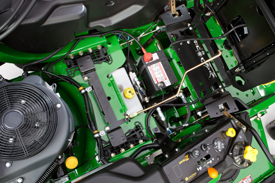 Flip-up seat
Flip-up seat
Onboard maintenance chart
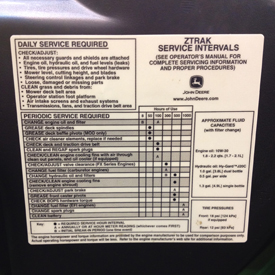 Maintenance chart
Maintenance chart
All ZTrak™ Mowers come with an onboard maintenance chart that is conveniently located inside the right-hand console. The service interval chart gives necessary service intervals.
Diagnostics
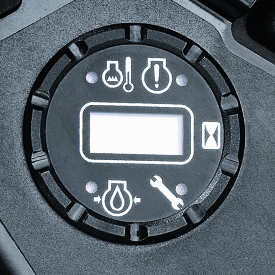 Hour meter (M Series pictured)
Hour meter (M Series pictured)
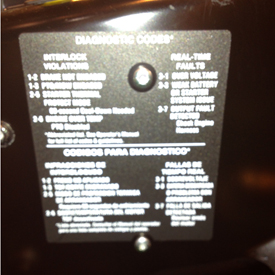 Diagnostic chart
Diagnostic chart
The hour meter shows the number of hours the machine is run when the key switch is in the on position. It only counts the hours the engine is actually running. Machine diagnostics are the first step of a monitoring system to help operators quickly diagnose common downtime issues. A trouble code light is included on the hour meter.
Use of the hour meter and service interval chart helps determine when the machine will need service.
Rollover protective structure (ROPS) enhances operator safety
 ROPS up
ROPS up
 ROPS mid position
ROPS mid position
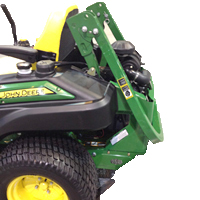 ROPS down position
ROPS down position
The ZTrak™ Z900E, M, and R Series Mowers are equipped with a standard two-post folding ROPS and seat belt. The folding ROPS enhances operator safety and provides ample clearance when storing the mower in garages or sheds:
- ISO21299 certification
- Foldable
The ROPS system can be repositioned without the use of tools. Under normal operation, the ROPS should be in the up position. If operating in low clearance areas, they can be folded and secured out of the way. The ROPS can also be pinned halfway down to accommodate machines equipped with a material collection system.
Three-year, bumper-to-bumper warranty
 Z955M ZTrak™ Mower
Z955M ZTrak™ Mower
 Z955R ZTrak Mower
Z955R ZTrak Mower
E and M Series 3-year, 1200-hour bumper-to-bumper warranty
An exclusive 2-year, unlimited hour/3-year, 1200-hour (whichever comes first) bumper-to-bumper warranty is standard for all John Deere E and M Series Mowers. The warranty is best in its class and places John Deere at the forefront of commercial mowing. It is also hassle free, with one company handling all of the paperwork.
NOTE: 36 months or 1200 hours, whichever comes first. For the first 24 months, there is no hour limitation.
R Series 3-year, 1500-hour bumper-to-bumper warranty
An exclusive 2-year, unlimited hour/3-year, 1500-hour (whichever comes first) bumper-to-bumper warranty is standard on all John Deere R Series mowers. The warranty is best in the industry and puts John Deere at the forefront of commercial mowing. It is also hassle free, with one company handling all of the paperwork.
NOTE: 36 months or 1500 hours, whichever comes first. For the first 24 months, there is no hour limitation.
Mower decks are safety certified
 Z950M ZTrak Mower
Z950M ZTrak Mower
Mowers decks are evaluated by the manufacturer (John Deere Turf Care) and conform to American National Standards Institute (ANSI) B71.4 2004 safety certification specifications for commercial turf care equipment.
Durable 7-Iron™ PRO decks pressed from a single piece of steel
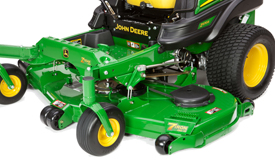 72-in. (183-cm) 7-Iron PRO deck shown
72-in. (183-cm) 7-Iron PRO deck shown
The ZTrak™ M and R Series Mowers are equipped with either a side-discharge or Mulch On Demand™ 7-Iron PRO deck.
7-Iron PRO mower decks have demonstrated quality, performance, and durability. They deliver a high quality cut in diverse conditions.
Key features of the 7-Iron PRO mower deck:
- Deck is stamped from 7-gauge, 0.179-in. (4.6-mm) steel to minimize the number of welds and provide a smooth underside with fewer sharp corners for reduced material buildup.
- Significantly fewer welds on the deck shell to wear or break - it is stamped from a single sheet of steel rather than multiple fabrications. An anti-skid step on the deck provides easy machine mounting.
- Higher blade tip speed than many competitors - 18,500 fpm (5,639 m/min) for more blade cuts per inch mowed.
- A deep-deck design of 5.5 in. (14 cm) delivers excellent airflow so material can be processed quickly and efficiently.
- The wider and higher discharge opening provides even clipping dispersal for an excellent finished appearance in all conditions.
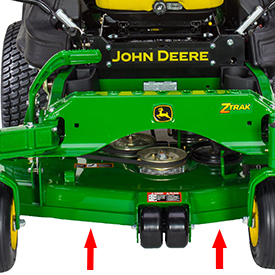 Mower rectangular leading-edge reinforcement
Mower rectangular leading-edge reinforcement
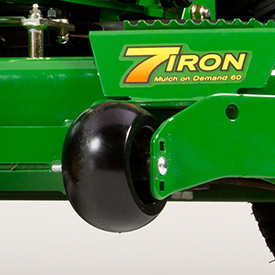 Dual-captured anti-scalp wheel
Dual-captured anti-scalp wheel
Key features of the 7-Iron PRO mower deck:
- Deck has rectangular leading deck edge reinforcement and the rounded corners of the stamped deck help distribute impact stress to reduce the potential of damage when the mower contacts trees, rocks, curbs, and other fixed obstacles.
- Dual-captured front and rear anti-scalp wheels provide deck flotation over even the toughest terrain.
- Three 1-in. (2.5-cm), cold-forged spindles are heat-treated for strength without bulk and are supported by ball bearings, providing reliability and performance; spindle housings are ribbed cast aluminum providing both excellent strength and heat dissipation.
- The front edge is raised above the blade plane to allow even cutting of tall grass and is reinforced with a square bar for durability. The front baffle has been redesigned to better manage airflow and control clippings.
- Three spindle grease fittings are accessible from the top.
- Blade overlap is 1.6 in. (40.6 mm), nearly 0.79 in. (20 mm) greater than previous decks, to reduce striping between blades.
- Quick-change, cutting-height adjustment.
7-Iron PRO mower deck
| M Series | R Series |
| Z920M - 48 in. (122 cm), 54 in. (137 cm), 60 in. (152 cm) | Z930R - 54 in. (137 cm), 60 in. (152 cm) |
| Z930M - 54 in. (137 cm), 60 in. (152 cm) | Z950R - 60 in. (152 cm), 72 in. (183 cm) |
| Z945M EFI - 60 in. (152 cm) | Z955R EFI - 60 in. (152 cm) |
| Z950M - 60 in. (152 cm), 72 in. (183 cm) | Z970R - 60 in. (152 cm), 72 in. (183 cm) |
| Z955M EFI - 60 in. (152 cm), 72 in. (183 cm) | |
| Z960M - 60 in. (152 cm), 72 in. (183 cm) |
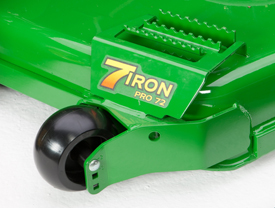 Mower deck step shown on 72-in. (183-cm) mower
Mower deck step shown on 72-in. (183-cm) mower
The deck step safely aids the operator's entrance and egress from machine.
Available Mulch On Demand™ deck
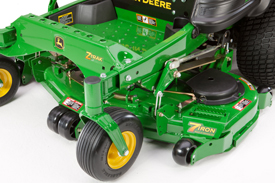 Mulch On Demand mower deck
Mulch On Demand mower deck
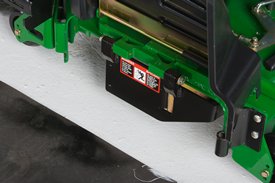 Mower deck with chute closed
Mower deck with chute closed
The Mulch On Demand mower deck delivers unprecedented levels of productivity and versatility to commercial mower operation. With the ability to switch between side discharge and mulching operation with the flip of a lever as the operator mows, keeping most clippings out of landscaping features and where they are wanted is extremely easy.
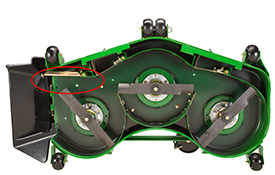 Mulch On Demand open
Mulch On Demand open
![Mulch On Demand closed (latch standard on material collection system [MCS] equipped models only)](https://salesmanual.deere.com/sales/salesmanual/images/NA/commercial_mowers/features_attachment/ztraks_com/480295_mod_deck_oval_275x175.jpg) Mulch On Demand closed (latch standard on material collection system [MCS] equipped models only)
Mulch On Demand closed (latch standard on material collection system [MCS] equipped models only)
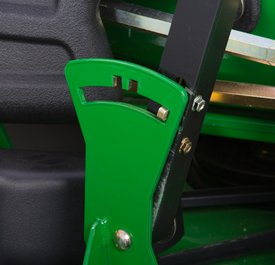 Lever position open (latch standard on MCS-equipped models only)
Lever position open (latch standard on MCS-equipped models only)
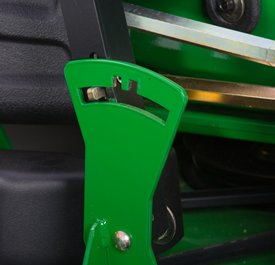 Lever position closed
Lever position closed
Key features of the 7-Iron™ PRO Mulch On Demand mower deck:
- Deck can be converted from a wide-open side discharge mode to a fully chambered mulching mode with a single move of a lever.
- NOTE: Mulch On Demand decks are a balance between a side discharge deck and a side discharge deck with a mulching kit.
- Deck is stamped from 7-gauge, 0.179-in. (4.6-mm) steel to minimize the number of welds and provide a smooth underside, with fewer sharp corners, for reduced material buildup.
- Significantly fewer welds on the deck shell to wear or break- it is stamped from a single sheet of steel rather than multiple fabrications. Anti-skid step on the deck provides for easy machine mounting.
- Mulch On Demand decks are superior to aftermarket chute blockers due to the movable baffles.
- Higher blade tip speed than many competitors - 18,500 fpm (5,639 m/min) for more blade cuts per inch mowed.
- Rounded corners of the stamped deck help distribute impact stress to reduce the potential of damage when the mower contacts trees, rocks, curbs, and other fixed obstacles.
- Deep-deck design of 5.5 in. (14 cm) delivers excellent airflow so material can be processed quickly and efficiently.
- Wider and higher discharge opening provides even clipping dispersal for an excellent finished appearance in all conditions.
- Three 1-in. (2.5 cm) cold-forged spindles are heat-treated for strength without bulk and are supported by ball bearings, providing reliability and performance; spindle housings are ribbed cast aluminum providing both excellent strength and heat dissipation.
- The front edge is raised above the blade plane to allow even cutting of tall grass and reinforced with a square bar for durability. The front baffle has been redesigned to better manage airflow and control clippings.
- Dual-captured anti-scalp wheels provide deck flotation over even the toughest terrain.
- Three greasable spindle zerks accessible from the top.
- Blade overlap is 1.6 in. (40 mm), nearly 0.79 in. (20 mm) greater than previous decks, to reduce striping between blades.
- Quick-change, cutting-height adjustment.
7-Iron PRO Mulch On Demand mower deck
| M Series | R Series |
| Z920M - 48-in. (122-cm) Mulch On Demand | Z930R - 54-in. (137-cm) Mulch On Demand |
| Z930M - 54-in. (137-cm) Mulch On Demand Z930M - 60-in. (152-cm) Mulch On Demand |
Z950R - 60-in. (152-cm) Mulch On Demand |
| Z945M EFI - 60-in. (152-cm) Mulch On Demand | Z970R - 60-in. (152-cm) Mulch On Demand |
| Z950M - 60-in. (152-cm) Mulch On Demand | |
| Z955M EFI - 60-in. (152-cm) Mulch On Demand | |
| Z960M - 60-in. (152-cm) Mulch On Demand |
Spindle assembly provides greater performance and reliability
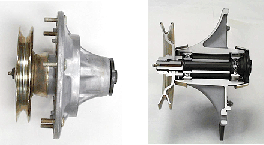 Spindle assembly
Spindle assembly
On every John Deere ZTrak™ mower deck, there are three 1-in. (2.5-cm) spindles that are cold-forged and heat-treated for strength without bulk. The spindles are supported by precision ball bearings, providing great performance and reliability.
The spindle housing is made of aircraft-grade, ribbed cast aluminum. This unique casting design embosses reinforcing gussets in the housing, which adds both strength and cooling surface area that stands up to commercial applications.
These spindles can be greased from the top and require no disassembly to reach. Grease channels provide lubrication to both bearings.
Features
Heavy-duty frame provides strength and durability
 Z955R EFI model shown with optional X® Tweel® Turf airless radial tire technology
Z955R EFI model shown with optional X® Tweel® Turf airless radial tire technology

The durability features of the frame are as follows:
-
Heavy-duty, thick-gauge, steel channel mainframe for strength and durability
-
Cast I-beam caster arms to handle the beating and pounding professional mowers receive
-
Wide-open access for maintenance and cleaning
Two-piece rear bumper provides protection
 Illustration of ZTrak™ mower rear bumper
Illustration of ZTrak™ mower rear bumper
A steel rear bumper provides protection for the machine. The bumper is made of two pieces, making it easy to remove and install when using a material collection system (MCS).
A rear hitch can be added to the steel bumper for towing purposes. ZTrak E, M, and R Series Mowers can tow up to 400 lb (181.4 kg).
Michelin, X, and Tweel are trademarks of Michelin North America, Inc.
Michelin® X® Tweel® Turf airless radial tire technology for ZTrak™ Mowers eliminates downtime and reduces cost of operation
 Flat-free rear tire shown on ZTrak Mower
Flat-free rear tire shown on ZTrak Mower
John Deere provides the commercial mower industry with the Michelin X Tweel Turf technology for Commercial ZTrak Mowers:
- 24x12N12 as an ordering option code for ZTrak Gas Mowers with 54 in., 60 in., and 72 in. (137-cm, 152-cm, and 183-cm) Mower Decks
- 24x12N12 is also available as base code equipment for ZTrak Gas Mowers with 54 in., 60 in., and 72 in. (137-cm, 152-cm, and 183-cm) Mower Decks (ordering information available at Configurator on the Tweel model page)
- 24x12N12 as an ordering option code for ZTrak Z994R Diesel with 54 in., 60 in., and 72 in. (137-cm, 152-cm, and 183 cm) Mower Decks
- 26x12N12 as an ordering option code for Z997R Diesel with 60 in. and 72 in. (152-cm and 183-cm) Mower Decks
Michelin is a world leader in tire manufacturing and technology. This airless radial tire solution is an industry first for John Deere, which provides an additional advantage to John Deere customers.
Advantages of the Michelin X Tweel Turf include:
- Mowing performance is improved.
- Rutting is reduced because the Michelin X Tweel Turf has more support across the surface for improved flotation and better ground contact.
- Unique energy transfer within the poly-resin spokes reduces the bounce associated with pneumatic tires.
- Excellent curb climbing is possible due to the Michelin X Tweel Turf construction and flexibility.
- More consistent cut quality is achieved because inconsistent tire pressure is eliminated.
- Uptime is improved.
- The exclusive technology eliminates downtime and associated cost due to flat or damaged tires.
- Punctures and sidewall damage no longer result in downtime.
- Cost of operation is reduced.
- Cost of repairs and maintenance is reduced. One single unit replaces the current tire, wheel, and valve assembly. There is no need for complex tire-mounting equipment.
- No need to spend time checking and optimizing tire pressure.
- The need to purchase and stock plug kits and spare tires is eliminated, particularly for professional landscape contractors and government agencies who normally stock them.
- The tire tread will last up to three times longer than current pneumatic tires because automotive-grade rubber is used for the tread.
 Michelin X Tweel Turf
Michelin X Tweel Turf
 Michelin X Tweel Turf
Michelin X Tweel Turf
Heavy-duty construction provides the ultimate in performance and reliable operation:
- High-strength poly-resin spokes carry the load.
- Four-hole, heavy-duty steel hub for durability.
- Deep, open-tread design provides excellent cleaning and traction.
- Zero degree, high-tensile proprietary carcass provides great lateral stiffness while resisting damage from impact and penetration.
NOTE: In some cases, different size Tweel tires are required depending on the mower deck size.
Tires deliver exceptional traction and maneuverability
 Drive tire
Drive tire
 Front caster tire
Front caster tire
The ZTrak R Series Mowers with 48-in. (122-cm) mower decks come with 24x9.5-12 4 PR drive tires. R Series Mowers with 54-in. (133-cm), 60-in. (152-cm) and 72-in. (183-cm) decks come with 24x12-12 4 PR drive tires. All R Series Mowers are equipped with 15x6-6 front flat-free tires for the following:
- Excellent traction, flotation, and curb climbing
- Low center of gravity to increase hillside mowing capability
- Caster wheels and caster wheel towers with sealed bearings for long life and easy steering
- Offset front caster wheels to help improve the inside corner-trim performance and reduce between-blade striping
Michelin, X, and Tweel are trademarks of Michelin North America, Inc.
Powerful 29-hp (21.6-kW) commercial-grade, electronically-fuel-injected engine delivers class-leading performance and efficiency
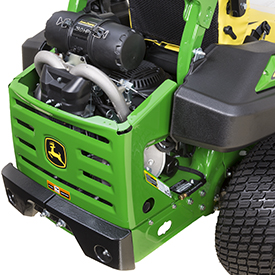 Electronic fuel injection (EFI) engine
Electronic fuel injection (EFI) engine
Get power, performance, and efficiency from the air-cooled, vertical shaft, EFI gas engine with 29 hp (21.6 kW).
Engine features include:
- Electronic, closed-loop electronic fuel injection system with oxygen sensor
- Up to 25 percent better fuel economy than typical carbureted engines of similar power
- Cleaner emissions
- Easier starting No choke control or cable
- Better recovery under load
- Automatic optimization for altitude (air pressure), air temperature, engine temperature, and fuel blends up to E10
- Onboard diagnostics (blink codes) and plug-in diagnostics (Service ADVISOR™ system) for EFI system trouble codes
- Overhead valve design
- More horsepower and torque per cubic inch of displacement
- Better fuel efficiency
- Full-pressure lubrication with full-flow filter
- Reduces engine wear by ensuring proper lubrication, even when operating on hillsides or uneven terrain
- Oil filter helps keep oil clean for increased engine life
- V-twin big block design
- Vertical shaft
- Easy-access, dual-element air filter
- 20-amp alternator
- Electric fuel pump
- Complies with strict U.S. Environmental Protection Agency (EPA) emission standards without loss of horsepower or torque
- Aluminum block engines
- Effectively dissipate heat
- Lightweight and strong construction
- Extend engine life due to elimination of debilitating engine temperatures
- Air-cooled engine design
Air cleaner filters out dust that can damage an engine
 Engine air cleaner
Engine air cleaner
 Air cleaner cover removed
Air cleaner cover removed
ZTrak™ Z900 Mowers are equipped with a dual-element, canister-style air filter, easily accessible from the rear of the machine without tools.
- The filtration system pulls clean air from above the engine, in turn filtering out the dust that can damage an engine over time.
- Filters are extremely easy to change when required.
- Pre-cleaner provides more protection against contamination in dusty and dirty applications.
Mow all day on a single tank of fuel with efficient and easy-to-fill fuel tank
 Fuel tank and filler neck
Fuel tank and filler neck
 Fuel filler neck
Fuel filler neck
The ZTrak™ Z900 Mowers are equipped with one single-fill, top-draw fuel tank:
- 11.5-U.S. gal. (43.5-L) capacity enables operators to mow all day without refueling.
- The fuel gauge makes it quick and easy to see how much fuel is in the tank.
- Top draw provides added safety.
- A large fuel-filler neck is angled to make it easy for an operator to complete the fueling process.
Under normal conditions, load, and operation, fuel consumption for the Z900 ZTrak Mowers is 1.5 U.S. gph (5.7 L/hr) to 2.2 U.S. gph (8.3 L/hr), depending on the horsepower and conditions.
Durable, hydrostatic drivetrain including cross porting delivers better cooling and provides easy access
 Heavy-duty ground drive
Heavy-duty ground drive
The hydrostatic drive included with the R Series Mowers features two 13-cc (0.8-cu in.) unitized hydraulic pumps combined with commercial-grade, heavy-duty, 13-cc (0.8-cu in.) wheel motors into a single unit. The R Series drive units feature cross porting, where the hydraulic fluid from the side doing the least work is filtered and then fed into the input of the side doing the most work. This ensures that the coolest fluid is going into the side working the hardest in order to provide the best performance during extended hillside operation in the same direction.
One pump and one motor drive each wheel on the ZTrak™ R Series Mowers. This provides several benefits:
- Exceptional cooling in high load conditions
- Easy-to-check level and refill hydraulic oil
- Opens up access under the seat
Two seat choices with ComfortGlide™ fore/aft suspension offer exceptional operator comfort
There are two seating options available for the R Series, all of which are factory installed
- Deluxe comfort seat with armrests and isolation
- Fully adjustable suspension seat with armrests
ComfortGlide fore/aft suspension
 ComfortGlide fore/aft suspension control lever
ComfortGlide fore/aft suspension control lever
Each seat has the ComfortGlide fore/aft suspension system that gives superior ride comfort over uneven areas:
- Seat can travel up to 2 in. (50.8 mm) fore and aft to absorb bumps for a significant enhancement to ride comfort.
- Control lever provides the ability to easily lock out fore/aft suspension movement if desired.
- One lever has three functions:
- Slide seat forward and back 3 in. (10.2 cm) to allow the operator the ability to choose the leg room needed
- Activate ComfortGlide fore/aft seat suspension
- Lock out ComfortGlide fore/aft seat suspension
Deluxe comfort seat with armrests and isolation
 Deluxe comfort seat with armrests and isolation
Deluxe comfort seat with armrests and isolation
 Rubber isolation mount
Rubber isolation mount
The deluxe comfort seat with armrests and isolation is available on the E, M, and R Series:
- Rubber springs are provided to isolate the seat base and to increase ride comfort.
- A convenient seat latch makes it easy to lift the seat.
- Isolation mounting is a good feature to reduce vibration for operators who do not require the fully adjustable suspension seat option.
- Factory installed on Z900s ordered with the deluxe comfort seat with armrests and isolation option.
Fully adjustable suspension seat with armrests
 Fully adjustable, mechanical suspension-seat
Fully adjustable, mechanical suspension-seat
 Suspension seat control
Suspension seat control
A fully adjustable suspension seat with armrests option is available on the M and R Series:
- Adjustable back angle is provided for individual operator comfort.
- Adjustable lumbar support helps to suit the needs of the operator.
- A suspension seat control dial gives easy adjustment for operator weight and ride comfort.
- A convenient seat latch provides ease of lifting the seat.
- On Z900s ordered with the fully adjustable suspension seat with armrests option, it is factory installed.
Designed for operator comfort
 Operator station
Operator station
 Operator station
Operator station
Two-lever hydrostatic control provides the following:
- The operator can select the ground speed and direction control simply by moving levers forward or reverse.
- Positive neutral lock position for levers provides added safety.
- Brake & Go operator-presence system returns levers to the neutral position when the brake pedal is actively engaged.
- Starting the machines is as easy as starting a car. It no longer matters if the control levers are extended out or pulled in, as long as the parking brake is engaged. Just turn the key and go.
- Wide-bend, large-diameter steering levers swing out easily for entry and exit from the operator platform.
Foot pegs
 Foot pegs available as standard on R-spec Z900’s
Foot pegs available as standard on R-spec Z900’s
Foot pegs help in providing the operator with a comfortable foot placement:
- Location and angle of foot pegs can be adjusted for individual operator comfort.
Foot platform isolators
 Foot platform isolators
Foot platform isolators
Foot platform isolators provide the operator with added comfort:
- Vibration to the legs and feet is reduced.
Brake & Go starting system
 Parking brake pedal (Z900R Series)
Parking brake pedal (Z900R Series)
 Parking brake lever (Z900 E and M Series)
Parking brake lever (Z900 E and M Series)
The Brake & Go starting system is a John Deere exclusive. This feature makes the starting process on all ZTrak™ mowers easier, while also making it possible to remove two interlock switches from the machine.
The Brake & Go starting procedure helps a novice operator look and feel like a professional. To start the machine, the parking brake must be engaged. It does not matter whether the power take-off (PTO) switch is on or off, nor does it matter if the control levers are pulled in or in the out position.
As long as the parking brake is engaged, the machine will start. When the parking brake is applied, the control levers cannot be moved to the forward or reverse positions.
Adjustable levers
 Adjustable levers
Adjustable levers
The motion control levers have two height positions and can also be adjusted forward or rearward within the slotted holes. The levers should be adjusted so the operator can achieve a full range of control operation comfortably.
Tracking adjustment
 Tracking adjustment
Tracking adjustment
The easy-to-turn (from-the-seat) tracking adjustment allows operators to keep their mowers straight and able to produce professional striping results.
Onboard storage and cup holder
 Onboard storage
Onboard storage
 Cup holder
Cup holder
Several storage areas are provided on the ZTrak machines. A convenient cup holder is also available.
Right-hand control panel
 Right-hand control panel
Right-hand control panel
 Right-hand control panel
Right-hand control panel
The controls are grouped together on the right console, providing one central location for key switch, throttle, PTO engagement, height-of-cut, diagnostics, and hour meter:
- Rocker-type PTO switch
- Height-of-cut knob with transport lock
- Key switch
- Hourmeter
- Throttle
- Separate choke control
- Easy choke operation yields less fouling of plugs
- No choke required for the electronic fuel injection (EFI) models
Easy-to-operate height-of-cut adjustment enables on-the-go changes
 Mower deck height adjustment knob
Mower deck height adjustment knob
An easy-to-use cutting-height lift system allows the operator to adjust the mower deck height with no tools and minimal effort. The easy-to-grip knob allows operators to dial in the desired height of cut (HOC).
Cutting height can be adjusted from approximately 1 in. to 5.5 in. (2.5 cm to 14 cm). Each increment on the knob adjusts the HOC approximately 0.25 in. (0.64 cm). The deck can also be raised and locked in a transport position to provide maximum ground clearance when moving the machine from one area to another.
The transport lock function allows the deck to be returned to the previous HOC after being in the transport position:
- Use the foot-lift pedal to lift the deck and engage the transport lock.
- Rotate the knob to adjust from 1 in. to 5.5 in. (2.5 cm to 14 cm) in 0.25-in. (0.64 cm) increments.
This design increases productivity by allowing operators to change the cutting height without having to leave the seat.
Standard comfort and convenience allows for easy deck height adjustment and power take-off (PTO) shutoff
 Comfort and convenience handles
Comfort and convenience handles
The comfort and convenience package combines large, ergonomically angled control levers with specially padded grips to provide unmatched comfort and reduced fatigue:
-
Keeps hands on the control sticks to minimize equipment damage and make them more comfortable over long operating days.
The control levers have built-in electronic controls to raise or lower the mower deck or disengage the mower blades.
 Control buttons
Control buttons
The push button (A) on the left motion control lever raises the mower deck.
The push button (B) on the right-hand control lever shuts off the PTO.
Once the PTO has been shut off using the button, the PTO switch must be pushed down and pulled up again to engage the PTO.
Mower is easy to service with many accessible components
 Z955R EFI left front view
Z955R EFI left front view
The design of the Z900 Series makes many service components reachable and easily accessible from the ground.
- Large, open engine compartment at the rear of the machine provides convenient servicing and ensures the engine heat is directed away from the operator.
 Flip-up foot panel
Flip-up foot panel
 Flip-up seat
Flip-up seat
Onboard maintenance chart
 Maintenance chart
Maintenance chart
All ZTrak™ Mowers come with an onboard maintenance chart that is conveniently located inside the right-hand console. The service interval chart gives necessary service intervals.
Diagnostics
 Hour meter (M Series pictured)
Hour meter (M Series pictured)
 Diagnostic chart
Diagnostic chart
The hour meter shows the number of hours the machine is run when the key switch is in the on position. It only counts the hours the engine is actually running. Machine diagnostics are the first step of a monitoring system to help operators quickly diagnose common downtime issues. A trouble code light is included on the hour meter.
Use of the hour meter and service interval chart helps determine when the machine will need service.
Rollover protective structure (ROPS) enhances operator safety
 ROPS up
ROPS up
 ROPS mid position
ROPS mid position
 ROPS down position
ROPS down position
The ZTrak™ Z900E, M, and R Series Mowers are equipped with a standard two-post folding ROPS and seat belt. The folding ROPS enhances operator safety and provides ample clearance when storing the mower in garages or sheds:
- ISO21299 certification
- Foldable
The ROPS system can be repositioned without the use of tools. Under normal operation, the ROPS should be in the up position. If operating in low clearance areas, they can be folded and secured out of the way. The ROPS can also be pinned halfway down to accommodate machines equipped with a material collection system.
Three-year, bumper-to-bumper warranty
 Z955M ZTrak™ Mower
Z955M ZTrak™ Mower
 Z955R ZTrak Mower
Z955R ZTrak Mower
E and M Series 3-year, 1200-hour bumper-to-bumper warranty
An exclusive 2-year, unlimited hour/3-year, 1200-hour (whichever comes first) bumper-to-bumper warranty is standard for all John Deere E and M Series Mowers. The warranty is best in its class and places John Deere at the forefront of commercial mowing. It is also hassle free, with one company handling all of the paperwork.
NOTE: 36 months or 1200 hours, whichever comes first. For the first 24 months, there is no hour limitation.
R Series 3-year, 1500-hour bumper-to-bumper warranty
An exclusive 2-year, unlimited hour/3-year, 1500-hour (whichever comes first) bumper-to-bumper warranty is standard on all John Deere R Series mowers. The warranty is best in the industry and puts John Deere at the forefront of commercial mowing. It is also hassle free, with one company handling all of the paperwork.
NOTE: 36 months or 1500 hours, whichever comes first. For the first 24 months, there is no hour limitation.
Mower decks are safety certified
 Z950M ZTrak Mower
Z950M ZTrak Mower
Mowers decks are evaluated by the manufacturer (John Deere Turf Care) and conform to American National Standards Institute (ANSI) B71.4 2004 safety certification specifications for commercial turf care equipment.
Durable 7-Iron™ PRO decks pressed from a single piece of steel
 72-in. (183-cm) 7-Iron PRO deck shown
72-in. (183-cm) 7-Iron PRO deck shown
The ZTrak™ M and R Series Mowers are equipped with either a side-discharge or Mulch On Demand™ 7-Iron PRO deck.
7-Iron PRO mower decks have demonstrated quality, performance, and durability. They deliver a high quality cut in diverse conditions.
Key features of the 7-Iron PRO mower deck:
- Deck is stamped from 7-gauge, 0.179-in. (4.6-mm) steel to minimize the number of welds and provide a smooth underside with fewer sharp corners for reduced material buildup.
- Significantly fewer welds on the deck shell to wear or break - it is stamped from a single sheet of steel rather than multiple fabrications. An anti-skid step on the deck provides easy machine mounting.
- Higher blade tip speed than many competitors - 18,500 fpm (5,639 m/min) for more blade cuts per inch mowed.
- A deep-deck design of 5.5 in. (14 cm) delivers excellent airflow so material can be processed quickly and efficiently.
- The wider and higher discharge opening provides even clipping dispersal for an excellent finished appearance in all conditions.
 Mower rectangular leading-edge reinforcement
Mower rectangular leading-edge reinforcement
 Dual-captured anti-scalp wheel
Dual-captured anti-scalp wheel
Key features of the 7-Iron PRO mower deck:
- Deck has rectangular leading deck edge reinforcement and the rounded corners of the stamped deck help distribute impact stress to reduce the potential of damage when the mower contacts trees, rocks, curbs, and other fixed obstacles.
- Dual-captured front and rear anti-scalp wheels provide deck flotation over even the toughest terrain.
- Three 1-in. (2.5-cm), cold-forged spindles are heat-treated for strength without bulk and are supported by ball bearings, providing reliability and performance; spindle housings are ribbed cast aluminum providing both excellent strength and heat dissipation.
- The front edge is raised above the blade plane to allow even cutting of tall grass and is reinforced with a square bar for durability. The front baffle has been redesigned to better manage airflow and control clippings.
- Three spindle grease fittings are accessible from the top.
- Blade overlap is 1.6 in. (40.6 mm), nearly 0.79 in. (20 mm) greater than previous decks, to reduce striping between blades.
- Quick-change, cutting-height adjustment.
7-Iron PRO mower deck
| M Series | R Series |
| Z920M - 48 in. (122 cm), 54 in. (137 cm), 60 in. (152 cm) | Z930R - 54 in. (137 cm), 60 in. (152 cm) |
| Z930M - 54 in. (137 cm), 60 in. (152 cm) | Z950R - 60 in. (152 cm), 72 in. (183 cm) |
| Z945M EFI - 60 in. (152 cm) | Z955R EFI - 60 in. (152 cm) |
| Z950M - 60 in. (152 cm), 72 in. (183 cm) | Z970R - 60 in. (152 cm), 72 in. (183 cm) |
| Z955M EFI - 60 in. (152 cm), 72 in. (183 cm) | |
| Z960M - 60 in. (152 cm), 72 in. (183 cm) |
 Mower deck step shown on 72-in. (183-cm) mower
Mower deck step shown on 72-in. (183-cm) mower
The deck step safely aids the operator's entrance and egress from machine.
Spindle assembly provides greater performance and reliability
 Spindle assembly
Spindle assembly
On every John Deere ZTrak™ mower deck, there are three 1-in. (2.5-cm) spindles that are cold-forged and heat-treated for strength without bulk. The spindles are supported by precision ball bearings, providing great performance and reliability.
The spindle housing is made of aircraft-grade, ribbed cast aluminum. This unique casting design embosses reinforcing gussets in the housing, which adds both strength and cooling surface area that stands up to commercial applications.
These spindles can be greased from the top and require no disassembly to reach. Grease channels provide lubrication to both bearings.
Features
Heavy-duty frame provides strength and durability
 Z955R EFI model shown with optional X® Tweel® Turf airless radial tire technology
Z955R EFI model shown with optional X® Tweel® Turf airless radial tire technology

The durability features of the frame are as follows:
-
Heavy-duty, thick-gauge, steel channel mainframe for strength and durability
-
Cast I-beam caster arms to handle the beating and pounding professional mowers receive
-
Wide-open access for maintenance and cleaning
Two-piece rear bumper provides protection
 Illustration of ZTrak™ mower rear bumper
Illustration of ZTrak™ mower rear bumper
A steel rear bumper provides protection for the machine. The bumper is made of two pieces, making it easy to remove and install when using a material collection system (MCS).
A rear hitch can be added to the steel bumper for towing purposes. ZTrak E, M, and R Series Mowers can tow up to 400 lb (181.4 kg).
Michelin, X, and Tweel are trademarks of Michelin North America, Inc.
Michelin® X® Tweel® Turf airless radial tire technology for ZTrak™ Mowers eliminates downtime and reduces cost of operation
 Flat-free rear tire shown on ZTrak Mower
Flat-free rear tire shown on ZTrak Mower
John Deere provides the commercial mower industry with the Michelin X Tweel Turf technology for Commercial ZTrak Mowers:
- 24x12N12 as an ordering option code for ZTrak Gas Mowers with 54 in., 60 in., and 72 in. (137-cm, 152-cm, and 183-cm) Mower Decks
- 24x12N12 is also available as base code equipment for ZTrak Gas Mowers with 54 in., 60 in., and 72 in. (137-cm, 152-cm, and 183-cm) Mower Decks (ordering information available at Configurator on the Tweel model page)
- 24x12N12 as an ordering option code for ZTrak Z994R Diesel with 54 in., 60 in., and 72 in. (137-cm, 152-cm, and 183 cm) Mower Decks
- 26x12N12 as an ordering option code for Z997R Diesel with 60 in. and 72 in. (152-cm and 183-cm) Mower Decks
Michelin is a world leader in tire manufacturing and technology. This airless radial tire solution is an industry first for John Deere, which provides an additional advantage to John Deere customers.
Advantages of the Michelin X Tweel Turf include:
- Mowing performance is improved.
- Rutting is reduced because the Michelin X Tweel Turf has more support across the surface for improved flotation and better ground contact.
- Unique energy transfer within the poly-resin spokes reduces the bounce associated with pneumatic tires.
- Excellent curb climbing is possible due to the Michelin X Tweel Turf construction and flexibility.
- More consistent cut quality is achieved because inconsistent tire pressure is eliminated.
- Uptime is improved.
- The exclusive technology eliminates downtime and associated cost due to flat or damaged tires.
- Punctures and sidewall damage no longer result in downtime.
- Cost of operation is reduced.
- Cost of repairs and maintenance is reduced. One single unit replaces the current tire, wheel, and valve assembly. There is no need for complex tire-mounting equipment.
- No need to spend time checking and optimizing tire pressure.
- The need to purchase and stock plug kits and spare tires is eliminated, particularly for professional landscape contractors and government agencies who normally stock them.
- The tire tread will last up to three times longer than current pneumatic tires because automotive-grade rubber is used for the tread.
 Michelin X Tweel Turf
Michelin X Tweel Turf
 Michelin X Tweel Turf
Michelin X Tweel Turf
Heavy-duty construction provides the ultimate in performance and reliable operation:
- High-strength poly-resin spokes carry the load.
- Four-hole, heavy-duty steel hub for durability.
- Deep, open-tread design provides excellent cleaning and traction.
- Zero degree, high-tensile proprietary carcass provides great lateral stiffness while resisting damage from impact and penetration.
NOTE: In some cases, different size Tweel tires are required depending on the mower deck size.
Tires deliver exceptional traction and maneuverability
 Drive tire
Drive tire
 Front caster tire
Front caster tire
The ZTrak R Series Mowers with 48-in. (122-cm) mower decks come with 24x9.5-12 4 PR drive tires. R Series Mowers with 54-in. (133-cm), 60-in. (152-cm) and 72-in. (183-cm) decks come with 24x12-12 4 PR drive tires. All R Series Mowers are equipped with 15x6-6 front flat-free tires for the following:
- Excellent traction, flotation, and curb climbing
- Low center of gravity to increase hillside mowing capability
- Caster wheels and caster wheel towers with sealed bearings for long life and easy steering
- Offset front caster wheels to help improve the inside corner-trim performance and reduce between-blade striping
Michelin, X, and Tweel are trademarks of Michelin North America, Inc.
Powerful 27-hp (20.1-kW) commercial-grade engine delivers class-leading performance and efficiency
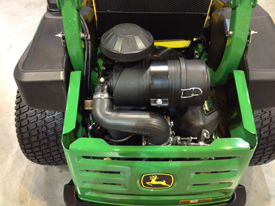 Z950M and Z950R engine
Z950M and Z950R engine

The Z950M and Z950R are powered by an air-cooled, vertical shaft engine:
- 27-hp (20.1-kW) gas engine
Engine features include:
- Overhead valve design
- More horsepower and torque per cubic inch of displacement
- Better fuel efficiency
- Full-pressure lubrication with full-flow filter
- Reduces engine wear by ensuring proper lubrication, even when operating on hillsides or uneven terrain
- Oil filter helps keep oil clean for increased engine life
- V-twin big block design
- Vertical shaft
- Easy-access, dual-element air filter with quick-release latch
- 15-amp alternator
- Fuel pump
- Complies with strict Environmental Protection Agency (EPA) and California Air Resources Board (CARB) emission standards without loss of horsepower or torque
- Aluminum block engines
- Effectively dissipate heat
- Lightweight and strong construction
- Extend engine life due to elimination of debilitating engine temperatures
- Air-cooled engine design
Air cleaner filters out dust that can damage an engine
 Engine air cleaner
Engine air cleaner
 Air cleaner cover removed
Air cleaner cover removed
ZTrak™ Z900 Mowers are equipped with a dual-element, canister-style air filter, easily accessible from the rear of the machine without tools.
- The filtration system pulls clean air from above the engine, in turn filtering out the dust that can damage an engine over time.
- Filters are extremely easy to change when required.
- Pre-cleaner provides more protection against contamination in dusty and dirty applications.
Mow all day on a single tank of fuel with efficient and easy-to-fill fuel tank
 Fuel tank and filler neck
Fuel tank and filler neck
 Fuel filler neck
Fuel filler neck
The ZTrak™ Z900 Mowers are equipped with one single-fill, top-draw fuel tank:
- 11.5-U.S. gal. (43.5-L) capacity enables operators to mow all day without refueling.
- The fuel gauge makes it quick and easy to see how much fuel is in the tank.
- Top draw provides added safety.
- A large fuel-filler neck is angled to make it easy for an operator to complete the fueling process.
Under normal conditions, load, and operation, fuel consumption for the Z900 ZTrak Mowers is 1.5 U.S. gph (5.7 L/hr) to 2.2 U.S. gph (8.3 L/hr), depending on the horsepower and conditions.
Field-installed propane conversion kits for Commercial Walk-Behind Mowers, QuikTrak™ Mowers, and Commercial ZTrak™ Mowers
 Propane conversion kit on a Walk-Behind Mower
Propane conversion kit on a Walk-Behind Mower
 Propane conversion kit on a ZTrak Mower
Propane conversion kit on a ZTrak Mower
John Deere provides application-specific Environmental Protection Agency (EPA) approved field-installed propane conversion kits for specific John Deere Commercial Walk-Behind Mowers, QuikTrak Mowers, and ZTrak Mowers. The conversion kits include all components required to convert the engines to operate on propane fuel. Single-tank or dual-tank brackets (depending on the vehicle) are provided for securely holding the propane tank(s) to the vehicle.
Propane tanks are not included.
An optional altitude kit is required when operating at altitudes above 2000 ft (610 m). The operator’s manual with the propane conversion kit provides further details. Parts must be ordered separately through John Deere Parts.
Propane facts:
- Propane is flammable and commonly used as a fuel.
- The molecular formula of propane is C3H8, and it is in the family of liquefied petroleum gases (LP gases). The other LP gases include butane, propylene, butadiene, butylene, isobutylene, and mixtures thereof.
- Propane is commonly available and has proven to be a dependable, safe, economical, and clean-burning fuel. It can be used as household fuel, industrial fuel, and fuel for internal combustion engines. Propane has been used as a fuel since 1910.
- At atmospheric pressure, propane boils at -44°F (-42.2°C), meaning it typically exists as a vapor. However, when contained under pressure, such as in a propane cylinder, it can exist as a liquid.
- Propane is naturally odorless, but includes an additive odorant, usually mercaptan, which gives it a distinct odor.
- Vapor propane is heavier than air, meaning it will settle in low areas such as along the ground or in drains.
Advantages of John Deere propane conversion kits include:
- Reduced fuel costs, up to 30 percent depending on fuel prices
- Lower emissions
- Reduced fuel-system maintenance
- Maintains John Deere warranty
- EPA and CARB certified
- May qualify for national and state rebate and incentive programs. Please visit www.propane.com/commercial-landscape/programs-and-incentives/ for further information.
Propane tank mounting bracket options:
 Single propane tank shown on QuikTrak Mower
Single propane tank shown on QuikTrak Mower
 Dual propane tanks shown on ZTrak Mower
Dual propane tanks shown on ZTrak Mower
Optional tank configurations and sizes are available to provide operators the ability to tailor for run time:
- Commercial Walk-Behind Mowers have only a single-tank mounting option.
- The single-tank bracket is designed for one 20-lb (9.1-kg) or 33-lb (15-kg) Worthington tank.
- Tank is not included.
- The single-tank bracket is designed for one 20-lb (9.1-kg) or 33-lb (15-kg) Worthington tank.
- QuikTrak Mowers have single-tank and dual-tank mounting options.
- The single-tank, right-side bracket is designed for one 33-lb (15-kg) Worthington tank.
- Tank is not included.
- The dual-tank brackets are designed for two 20-lb (9.1-kg) Worthington tanks.
- Tanks are not included.
- The single-tank, right-side bracket is designed for one 33-lb (15-kg) Worthington tank.
- ZTrak Mowers have single-tank and dual-tank mounting options.
- The single-tank, left-side bracket is designed for one 33-lb (15-kg) or 43-lb (19.5-kg) Worthington tank.
- Tank is not included.
- The dual-tank brackets are designed for two 33-lb (15-kg) Worthington tanks.
- Tanks are not included.
- ZTrak Mowers with dual-tank configurations are not compatible with any material collection systems.
NOTE: Reference the Propane and Attachment Compatibility Chart to determine tank configurations that are compatible.
Estimated run-time comparison
| Engine displacement | FS603cc | FS726cc | FX726cc | FX852cc |
| Average consumption (lb [kg]/hr) | 3.9 (1.8) | 4.2 (1.9) | 4.2 (1.9) | 5.8 (2.6) |
| Run time (hours) with 20-lb (9.1-kg) tank | 5.1 | 4.8 | 4.8 | 3.4 |
| Run time (hours) with 33.5-lb (15.2-kg) tank | Not available | 8.0 | 8.0 | 5.8 |
| Run time (hours) with 43.5-lb (19.7-kg) tank | Not available | 10.4 | 10.4 | 7.5 |
Field-installed propane conversion kit compatibility:
NOTE: Conversion to propane is not intended for units with engines having more than 250 hours of use.
Commercial Walk-Behind Mowers (model year 2018 and prior)
| WG Series | WH Series | WHP Series | |||||||||
| Model | WG32A | WG36A | WG48A | WH36A | WH48A | WH52A | WH61A | WHP36A | WHP48A | WHP52A | WHP61A |
| Engine model | FS481V | FS481V | FS481V | FS481V | FS600V | FS600V | FS691V | FS481V | FS600V | FS600V | FS691V |
| Engine displacement | 603 cc | 603 cc | 603 cc | 603 cc | 603 cc | 603 cc | 726 cc | 603 cc | 603 cc | 603 cc | 726 cc |
| Propane kit model number | Not available | Not available | Not available | FS603cc | FS603cc | FS603cc | FS726cc | FS603cc | FS603cc | FS603cc | FS726cc |
QuikTrak Mowers
| E Series | M Series | R Series | |||||||
| Model | 652E | 636M | 648M | 652M | 648R | 652R | 652R EFI | 661R | 661R EFI |
| Engine model | FX691V | FS600V | FX691V | FX691V | FX691V | FX730V | ECV740 EFI | FX730V | ECV740 EFI |
| Engine displacement | 726 cc | 603 cc | 726 cc | 726 cc | 726 cc | 726 cc | 747 cc | 726 cc | 747 cc |
| Propane kit model number | FX726cc | Not available | Not available | Not available | FX726cc | FX726cc | Not available | FX726cc | Not available |
Commercial ZTrak Mowers
| E Series | M Series | R Series | |||||||||
| Model | Z915E | Z920M | Z930M | Z945M EFI | Z950M | Z955M EFI | Z960M | Z930R | Z950R | Z955R EFI | Z970R |
| Engine model | CV742 | FX730V | FX801V | ECV850 EFI | FX850V | ECV860J EFI | FX921V | FX801V | FX850V | ECV860J EFI | FX1000V |
| Engine displacement | 747 cc | 726 cc | 852 cc | 824 cc | 852 cc | 824 cc | 999 cc | 852 cc | 852 cc | 824 cc | 999 cc |
| Propane kit model number | Not available | FX726cc* | FX852cc* | Not available | FX852cc* | Not available | Not available | FX852cc* | FX852cc* | Not available | Not available |
Worthington tanks are manufactured by Worthington Industries, Inc.
Durable, hydrostatic drivetrain including cross porting delivers better cooling and provides easy access
 Heavy-duty ground drive
Heavy-duty ground drive
The hydrostatic drive included with the R Series Mowers features two 13-cc (0.8-cu in.) unitized hydraulic pumps combined with commercial-grade, heavy-duty, 13-cc (0.8-cu in.) wheel motors into a single unit. The R Series drive units feature cross porting, where the hydraulic fluid from the side doing the least work is filtered and then fed into the input of the side doing the most work. This ensures that the coolest fluid is going into the side working the hardest in order to provide the best performance during extended hillside operation in the same direction.
One pump and one motor drive each wheel on the ZTrak™ R Series Mowers. This provides several benefits:
- Exceptional cooling in high load conditions
- Easy-to-check level and refill hydraulic oil
- Opens up access under the seat
Two seat choices with ComfortGlide™ fore/aft suspension offer exceptional operator comfort
There are two seating options available for the R Series, all of which are factory installed
- Deluxe comfort seat with armrests and isolation
- Fully adjustable suspension seat with armrests
ComfortGlide fore/aft suspension
 ComfortGlide fore/aft suspension control lever
ComfortGlide fore/aft suspension control lever
Each seat has the ComfortGlide fore/aft suspension system that gives superior ride comfort over uneven areas:
- Seat can travel up to 2 in. (50.8 mm) fore and aft to absorb bumps for a significant enhancement to ride comfort.
- Control lever provides the ability to easily lock out fore/aft suspension movement if desired.
- One lever has three functions:
- Slide seat forward and back 3 in. (10.2 cm) to allow the operator the ability to choose the leg room needed
- Activate ComfortGlide fore/aft seat suspension
- Lock out ComfortGlide fore/aft seat suspension
Deluxe comfort seat with armrests and isolation
 Deluxe comfort seat with armrests and isolation
Deluxe comfort seat with armrests and isolation
 Rubber isolation mount
Rubber isolation mount
The deluxe comfort seat with armrests and isolation is available on the E, M, and R Series:
- Rubber springs are provided to isolate the seat base and to increase ride comfort.
- A convenient seat latch makes it easy to lift the seat.
- Isolation mounting is a good feature to reduce vibration for operators who do not require the fully adjustable suspension seat option.
- Factory installed on Z900s ordered with the deluxe comfort seat with armrests and isolation option.
Fully adjustable suspension seat with armrests
 Fully adjustable, mechanical suspension-seat
Fully adjustable, mechanical suspension-seat
 Suspension seat control
Suspension seat control
A fully adjustable suspension seat with armrests option is available on the M and R Series:
- Adjustable back angle is provided for individual operator comfort.
- Adjustable lumbar support helps to suit the needs of the operator.
- A suspension seat control dial gives easy adjustment for operator weight and ride comfort.
- A convenient seat latch provides ease of lifting the seat.
- On Z900s ordered with the fully adjustable suspension seat with armrests option, it is factory installed.
Designed for operator comfort
 Operator station
Operator station
 Operator station
Operator station
Two-lever hydrostatic control provides the following:
- The operator can select the ground speed and direction control simply by moving levers forward or reverse.
- Positive neutral lock position for levers provides added safety.
- Brake & Go operator-presence system returns levers to the neutral position when the brake pedal is actively engaged.
- Starting the machines is as easy as starting a car. It no longer matters if the control levers are extended out or pulled in, as long as the parking brake is engaged. Just turn the key and go.
- Wide-bend, large-diameter steering levers swing out easily for entry and exit from the operator platform.
Foot pegs
 Foot pegs available as standard on R-spec Z900’s
Foot pegs available as standard on R-spec Z900’s
Foot pegs help in providing the operator with a comfortable foot placement:
- Location and angle of foot pegs can be adjusted for individual operator comfort.
Foot platform isolators
 Foot platform isolators
Foot platform isolators
Foot platform isolators provide the operator with added comfort:
- Vibration to the legs and feet is reduced.
Brake & Go starting system
 Parking brake pedal (Z900R Series)
Parking brake pedal (Z900R Series)
 Parking brake lever (Z900 E and M Series)
Parking brake lever (Z900 E and M Series)
The Brake & Go starting system is a John Deere exclusive. This feature makes the starting process on all ZTrak™ mowers easier, while also making it possible to remove two interlock switches from the machine.
The Brake & Go starting procedure helps a novice operator look and feel like a professional. To start the machine, the parking brake must be engaged. It does not matter whether the power take-off (PTO) switch is on or off, nor does it matter if the control levers are pulled in or in the out position.
As long as the parking brake is engaged, the machine will start. When the parking brake is applied, the control levers cannot be moved to the forward or reverse positions.
Adjustable levers
 Adjustable levers
Adjustable levers
The motion control levers have two height positions and can also be adjusted forward or rearward within the slotted holes. The levers should be adjusted so the operator can achieve a full range of control operation comfortably.
Tracking adjustment
 Tracking adjustment
Tracking adjustment
The easy-to-turn (from-the-seat) tracking adjustment allows operators to keep their mowers straight and able to produce professional striping results.
Onboard storage and cup holder
 Onboard storage
Onboard storage
 Cup holder
Cup holder
Several storage areas are provided on the ZTrak machines. A convenient cup holder is also available.
Right-hand control panel
 Right-hand control panel
Right-hand control panel
 Right-hand control panel
Right-hand control panel
The controls are grouped together on the right console, providing one central location for key switch, throttle, PTO engagement, height-of-cut, diagnostics, and hour meter:
- Rocker-type PTO switch
- Height-of-cut knob with transport lock
- Key switch
- Hourmeter
- Throttle
- Separate choke control
- Easy choke operation yields less fouling of plugs
- No choke required for the electronic fuel injection (EFI) models
Easy-to-operate height-of-cut adjustment enables on-the-go changes
 Mower deck height adjustment knob
Mower deck height adjustment knob
An easy-to-use cutting-height lift system allows the operator to adjust the mower deck height with no tools and minimal effort. The easy-to-grip knob allows operators to dial in the desired height of cut (HOC).
Cutting height can be adjusted from approximately 1 in. to 5.5 in. (2.5 cm to 14 cm). Each increment on the knob adjusts the HOC approximately 0.25 in. (0.64 cm). The deck can also be raised and locked in a transport position to provide maximum ground clearance when moving the machine from one area to another.
The transport lock function allows the deck to be returned to the previous HOC after being in the transport position:
- Use the foot-lift pedal to lift the deck and engage the transport lock.
- Rotate the knob to adjust from 1 in. to 5.5 in. (2.5 cm to 14 cm) in 0.25-in. (0.64 cm) increments.
This design increases productivity by allowing operators to change the cutting height without having to leave the seat.
Standard comfort and convenience allows for easy deck height adjustment and power take-off (PTO) shutoff
 Comfort and convenience handles
Comfort and convenience handles
The comfort and convenience package combines large, ergonomically angled control levers with specially padded grips to provide unmatched comfort and reduced fatigue:
-
Keeps hands on the control sticks to minimize equipment damage and make them more comfortable over long operating days.
The control levers have built-in electronic controls to raise or lower the mower deck or disengage the mower blades.
 Control buttons
Control buttons
The push button (A) on the left motion control lever raises the mower deck.
The push button (B) on the right-hand control lever shuts off the PTO.
Once the PTO has been shut off using the button, the PTO switch must be pushed down and pulled up again to engage the PTO.
Mower is easy to service with many accessible components
 Z955R EFI left front view
Z955R EFI left front view
The design of the Z900 Series makes many service components reachable and easily accessible from the ground.
- Large, open engine compartment at the rear of the machine provides convenient servicing and ensures the engine heat is directed away from the operator.
 Flip-up foot panel
Flip-up foot panel
 Flip-up seat
Flip-up seat
Onboard maintenance chart
 Maintenance chart
Maintenance chart
All ZTrak™ Mowers come with an onboard maintenance chart that is conveniently located inside the right-hand console. The service interval chart gives necessary service intervals.
Diagnostics
 Hour meter (M Series pictured)
Hour meter (M Series pictured)
 Diagnostic chart
Diagnostic chart
The hour meter shows the number of hours the machine is run when the key switch is in the on position. It only counts the hours the engine is actually running. Machine diagnostics are the first step of a monitoring system to help operators quickly diagnose common downtime issues. A trouble code light is included on the hour meter.
Use of the hour meter and service interval chart helps determine when the machine will need service.
Rollover protective structure (ROPS) enhances operator safety
 ROPS up
ROPS up
 ROPS mid position
ROPS mid position
 ROPS down position
ROPS down position
The ZTrak™ Z900E, M, and R Series Mowers are equipped with a standard two-post folding ROPS and seat belt. The folding ROPS enhances operator safety and provides ample clearance when storing the mower in garages or sheds:
- ISO21299 certification
- Foldable
The ROPS system can be repositioned without the use of tools. Under normal operation, the ROPS should be in the up position. If operating in low clearance areas, they can be folded and secured out of the way. The ROPS can also be pinned halfway down to accommodate machines equipped with a material collection system.
Three-year, bumper-to-bumper warranty
 Z955M ZTrak™ Mower
Z955M ZTrak™ Mower
 Z955R ZTrak Mower
Z955R ZTrak Mower
E and M Series 3-year, 1200-hour bumper-to-bumper warranty
An exclusive 2-year, unlimited hour/3-year, 1200-hour (whichever comes first) bumper-to-bumper warranty is standard for all John Deere E and M Series Mowers. The warranty is best in its class and places John Deere at the forefront of commercial mowing. It is also hassle free, with one company handling all of the paperwork.
NOTE: 36 months or 1200 hours, whichever comes first. For the first 24 months, there is no hour limitation.
R Series 3-year, 1500-hour bumper-to-bumper warranty
An exclusive 2-year, unlimited hour/3-year, 1500-hour (whichever comes first) bumper-to-bumper warranty is standard on all John Deere R Series mowers. The warranty is best in the industry and puts John Deere at the forefront of commercial mowing. It is also hassle free, with one company handling all of the paperwork.
NOTE: 36 months or 1500 hours, whichever comes first. For the first 24 months, there is no hour limitation.
Mower decks are safety certified
 Z950M ZTrak Mower
Z950M ZTrak Mower
Mowers decks are evaluated by the manufacturer (John Deere Turf Care) and conform to American National Standards Institute (ANSI) B71.4 2004 safety certification specifications for commercial turf care equipment.
Durable 7-Iron™ PRO decks pressed from a single piece of steel
 72-in. (183-cm) 7-Iron PRO deck shown
72-in. (183-cm) 7-Iron PRO deck shown
The ZTrak™ M and R Series Mowers are equipped with either a side-discharge or Mulch On Demand™ 7-Iron PRO deck.
7-Iron PRO mower decks have demonstrated quality, performance, and durability. They deliver a high quality cut in diverse conditions.
Key features of the 7-Iron PRO mower deck:
- Deck is stamped from 7-gauge, 0.179-in. (4.6-mm) steel to minimize the number of welds and provide a smooth underside with fewer sharp corners for reduced material buildup.
- Significantly fewer welds on the deck shell to wear or break - it is stamped from a single sheet of steel rather than multiple fabrications. An anti-skid step on the deck provides easy machine mounting.
- Higher blade tip speed than many competitors - 18,500 fpm (5,639 m/min) for more blade cuts per inch mowed.
- A deep-deck design of 5.5 in. (14 cm) delivers excellent airflow so material can be processed quickly and efficiently.
- The wider and higher discharge opening provides even clipping dispersal for an excellent finished appearance in all conditions.
 Mower rectangular leading-edge reinforcement
Mower rectangular leading-edge reinforcement
 Dual-captured anti-scalp wheel
Dual-captured anti-scalp wheel
Key features of the 7-Iron PRO mower deck:
- Deck has rectangular leading deck edge reinforcement and the rounded corners of the stamped deck help distribute impact stress to reduce the potential of damage when the mower contacts trees, rocks, curbs, and other fixed obstacles.
- Dual-captured front and rear anti-scalp wheels provide deck flotation over even the toughest terrain.
- Three 1-in. (2.5-cm), cold-forged spindles are heat-treated for strength without bulk and are supported by ball bearings, providing reliability and performance; spindle housings are ribbed cast aluminum providing both excellent strength and heat dissipation.
- The front edge is raised above the blade plane to allow even cutting of tall grass and is reinforced with a square bar for durability. The front baffle has been redesigned to better manage airflow and control clippings.
- Three spindle grease fittings are accessible from the top.
- Blade overlap is 1.6 in. (40.6 mm), nearly 0.79 in. (20 mm) greater than previous decks, to reduce striping between blades.
- Quick-change, cutting-height adjustment.
7-Iron PRO mower deck
| M Series | R Series |
| Z920M - 48 in. (122 cm), 54 in. (137 cm), 60 in. (152 cm) | Z930R - 54 in. (137 cm), 60 in. (152 cm) |
| Z930M - 54 in. (137 cm), 60 in. (152 cm) | Z950R - 60 in. (152 cm), 72 in. (183 cm) |
| Z945M EFI - 60 in. (152 cm) | Z955R EFI - 60 in. (152 cm) |
| Z950M - 60 in. (152 cm), 72 in. (183 cm) | Z970R - 60 in. (152 cm), 72 in. (183 cm) |
| Z955M EFI - 60 in. (152 cm), 72 in. (183 cm) | |
| Z960M - 60 in. (152 cm), 72 in. (183 cm) |
 Mower deck step shown on 72-in. (183-cm) mower
Mower deck step shown on 72-in. (183-cm) mower
The deck step safely aids the operator's entrance and egress from machine.
Available Mulch On Demand™ deck
 Mulch On Demand mower deck
Mulch On Demand mower deck
 Mower deck with chute closed
Mower deck with chute closed
The Mulch On Demand mower deck delivers unprecedented levels of productivity and versatility to commercial mower operation. With the ability to switch between side discharge and mulching operation with the flip of a lever as the operator mows, keeping most clippings out of landscaping features and where they are wanted is extremely easy.
 Mulch On Demand open
Mulch On Demand open
![Mulch On Demand closed (latch standard on material collection system [MCS] equipped models only)](https://salesmanual.deere.com/sales/salesmanual/images/NA/commercial_mowers/features_attachment/ztraks_com/480295_mod_deck_oval_275x175.jpg) Mulch On Demand closed (latch standard on material collection system [MCS] equipped models only)
Mulch On Demand closed (latch standard on material collection system [MCS] equipped models only)
 Lever position open (latch standard on MCS-equipped models only)
Lever position open (latch standard on MCS-equipped models only)
 Lever position closed
Lever position closed
Key features of the 7-Iron™ PRO Mulch On Demand mower deck:
- Deck can be converted from a wide-open side discharge mode to a fully chambered mulching mode with a single move of a lever.
- NOTE: Mulch On Demand decks are a balance between a side discharge deck and a side discharge deck with a mulching kit.
- Deck is stamped from 7-gauge, 0.179-in. (4.6-mm) steel to minimize the number of welds and provide a smooth underside, with fewer sharp corners, for reduced material buildup.
- Significantly fewer welds on the deck shell to wear or break- it is stamped from a single sheet of steel rather than multiple fabrications. Anti-skid step on the deck provides for easy machine mounting.
- Mulch On Demand decks are superior to aftermarket chute blockers due to the movable baffles.
- Higher blade tip speed than many competitors - 18,500 fpm (5,639 m/min) for more blade cuts per inch mowed.
- Rounded corners of the stamped deck help distribute impact stress to reduce the potential of damage when the mower contacts trees, rocks, curbs, and other fixed obstacles.
- Deep-deck design of 5.5 in. (14 cm) delivers excellent airflow so material can be processed quickly and efficiently.
- Wider and higher discharge opening provides even clipping dispersal for an excellent finished appearance in all conditions.
- Three 1-in. (2.5 cm) cold-forged spindles are heat-treated for strength without bulk and are supported by ball bearings, providing reliability and performance; spindle housings are ribbed cast aluminum providing both excellent strength and heat dissipation.
- The front edge is raised above the blade plane to allow even cutting of tall grass and reinforced with a square bar for durability. The front baffle has been redesigned to better manage airflow and control clippings.
- Dual-captured anti-scalp wheels provide deck flotation over even the toughest terrain.
- Three greasable spindle zerks accessible from the top.
- Blade overlap is 1.6 in. (40 mm), nearly 0.79 in. (20 mm) greater than previous decks, to reduce striping between blades.
- Quick-change, cutting-height adjustment.
7-Iron PRO Mulch On Demand mower deck
| M Series | R Series |
| Z920M - 48-in. (122-cm) Mulch On Demand | Z930R - 54-in. (137-cm) Mulch On Demand |
| Z930M - 54-in. (137-cm) Mulch On Demand Z930M - 60-in. (152-cm) Mulch On Demand |
Z950R - 60-in. (152-cm) Mulch On Demand |
| Z945M EFI - 60-in. (152-cm) Mulch On Demand | Z970R - 60-in. (152-cm) Mulch On Demand |
| Z950M - 60-in. (152-cm) Mulch On Demand | |
| Z955M EFI - 60-in. (152-cm) Mulch On Demand | |
| Z960M - 60-in. (152-cm) Mulch On Demand |
Spindle assembly provides greater performance and reliability
 Spindle assembly
Spindle assembly
On every John Deere ZTrak™ mower deck, there are three 1-in. (2.5-cm) spindles that are cold-forged and heat-treated for strength without bulk. The spindles are supported by precision ball bearings, providing great performance and reliability.
The spindle housing is made of aircraft-grade, ribbed cast aluminum. This unique casting design embosses reinforcing gussets in the housing, which adds both strength and cooling surface area that stands up to commercial applications.
These spindles can be greased from the top and require no disassembly to reach. Grease channels provide lubrication to both bearings.
Features
Heavy-duty frame provides strength and durability
 Z955R EFI model shown with optional X® Tweel® Turf airless radial tire technology
Z955R EFI model shown with optional X® Tweel® Turf airless radial tire technology

The durability features of the frame are as follows:
-
Heavy-duty, thick-gauge, steel channel mainframe for strength and durability
-
Cast I-beam caster arms to handle the beating and pounding professional mowers receive
-
Wide-open access for maintenance and cleaning
Two-piece rear bumper provides protection
 Illustration of ZTrak™ mower rear bumper
Illustration of ZTrak™ mower rear bumper
A steel rear bumper provides protection for the machine. The bumper is made of two pieces, making it easy to remove and install when using a material collection system (MCS).
A rear hitch can be added to the steel bumper for towing purposes. ZTrak E, M, and R Series Mowers can tow up to 400 lb (181.4 kg).
Michelin, X, and Tweel are trademarks of Michelin North America, Inc.
Michelin® X® Tweel® Turf airless radial tire technology for ZTrak™ Mowers eliminates downtime and reduces cost of operation
 Flat-free rear tire shown on ZTrak Mower
Flat-free rear tire shown on ZTrak Mower
John Deere provides the commercial mower industry with the Michelin X Tweel Turf technology for Commercial ZTrak Mowers:
- 24x12N12 as an ordering option code for ZTrak Gas Mowers with 54 in., 60 in., and 72 in. (137-cm, 152-cm, and 183-cm) Mower Decks
- 24x12N12 is also available as base code equipment for ZTrak Gas Mowers with 54 in., 60 in., and 72 in. (137-cm, 152-cm, and 183-cm) Mower Decks (ordering information available at Configurator on the Tweel model page)
- 24x12N12 as an ordering option code for ZTrak Z994R Diesel with 54 in., 60 in., and 72 in. (137-cm, 152-cm, and 183 cm) Mower Decks
- 26x12N12 as an ordering option code for Z997R Diesel with 60 in. and 72 in. (152-cm and 183-cm) Mower Decks
Michelin is a world leader in tire manufacturing and technology. This airless radial tire solution is an industry first for John Deere, which provides an additional advantage to John Deere customers.
Advantages of the Michelin X Tweel Turf include:
- Mowing performance is improved.
- Rutting is reduced because the Michelin X Tweel Turf has more support across the surface for improved flotation and better ground contact.
- Unique energy transfer within the poly-resin spokes reduces the bounce associated with pneumatic tires.
- Excellent curb climbing is possible due to the Michelin X Tweel Turf construction and flexibility.
- More consistent cut quality is achieved because inconsistent tire pressure is eliminated.
- Uptime is improved.
- The exclusive technology eliminates downtime and associated cost due to flat or damaged tires.
- Punctures and sidewall damage no longer result in downtime.
- Cost of operation is reduced.
- Cost of repairs and maintenance is reduced. One single unit replaces the current tire, wheel, and valve assembly. There is no need for complex tire-mounting equipment.
- No need to spend time checking and optimizing tire pressure.
- The need to purchase and stock plug kits and spare tires is eliminated, particularly for professional landscape contractors and government agencies who normally stock them.
- The tire tread will last up to three times longer than current pneumatic tires because automotive-grade rubber is used for the tread.
 Michelin X Tweel Turf
Michelin X Tweel Turf
 Michelin X Tweel Turf
Michelin X Tweel Turf
Heavy-duty construction provides the ultimate in performance and reliable operation:
- High-strength poly-resin spokes carry the load.
- Four-hole, heavy-duty steel hub for durability.
- Deep, open-tread design provides excellent cleaning and traction.
- Zero degree, high-tensile proprietary carcass provides great lateral stiffness while resisting damage from impact and penetration.
NOTE: In some cases, different size Tweel tires are required depending on the mower deck size.
Tires deliver exceptional traction and maneuverability
 Drive tire
Drive tire
 Front caster tire
Front caster tire
The ZTrak R Series Mowers with 48-in. (122-cm) mower decks come with 24x9.5-12 4 PR drive tires. R Series Mowers with 54-in. (133-cm), 60-in. (152-cm) and 72-in. (183-cm) decks come with 24x12-12 4 PR drive tires. All R Series Mowers are equipped with 15x6-6 front flat-free tires for the following:
- Excellent traction, flotation, and curb climbing
- Low center of gravity to increase hillside mowing capability
- Caster wheels and caster wheel towers with sealed bearings for long life and easy steering
- Offset front caster wheels to help improve the inside corner-trim performance and reduce between-blade striping
Michelin, X, and Tweel are trademarks of Michelin North America, Inc.
Powerful 25.5-hp (19.0-kW) commercial-grade engine delivers class-leading performance and efficiency
 Z930R engine
Z930R engine

The Z930R is powered by an air-cooled, vertical shaft engine:
- 25.5-hp (19.0-kW) gas engine
Engine features include:
- Overhead valve design
- More horsepower and torque per cubic inch of displacement
- Better fuel efficiency
- Full-pressure lubrication with full-flow filter
- Reduces engine wear by ensuring proper lubrication, even when operating on hillsides or uneven terrain
- Oil filter helps keep oil clean for increased engine life
- V-twin big block design
- Vertical shaft
- Easy-access, dual-element air filter with quick-release latch
- 20-amp alternator
- Fuel pump
- Complies with strict Environmental Protection Agency (EPA) and California Air Resources Board (CARB) emission standards without loss of horsepower or torque
- Aluminum block engines
- Effectively dissipate heat
- Lightweight and strong construction
- Extend engine life due to elimination of debilitating engine temperatures
- Air-cooled engine design
Air cleaner filters out dust that can damage an engine
 Engine air cleaner
Engine air cleaner
 Air cleaner cover removed
Air cleaner cover removed
ZTrak™ Z900 Mowers are equipped with a dual-element, canister-style air filter, easily accessible from the rear of the machine without tools.
- The filtration system pulls clean air from above the engine, in turn filtering out the dust that can damage an engine over time.
- Filters are extremely easy to change when required.
- Pre-cleaner provides more protection against contamination in dusty and dirty applications.
Mow all day on a single tank of fuel with efficient and easy-to-fill fuel tank
 Fuel tank and filler neck
Fuel tank and filler neck
 Fuel filler neck
Fuel filler neck
The ZTrak Z900 Mowers are equipped with one single-fill, top-draw fuel tank:
- 11.5-U.S. gal. (43.5-L) capacity enables operators to mow all day without refueling.
- The fuel gauge makes it quick and easy to see how much fuel is in the tank.
- Top draw provides added safety.
- A large fuel-filler neck is angled to make it easy for an operator to complete the fueling process.
Under normal conditions, load, and operation, fuel consumption for the Z900 ZTrak Mowers is 1.5 U.S. gph (5.7 L/hr) to 2.2 U.S. gph (8.3 L/hr), depending on the horsepower and conditions.
Field-installed propane conversion kits for Commercial Walk-Behind Mowers, QuikTrak™ Mowers, and Commercial ZTrak™ Mowers
 Propane conversion kit on a Walk-Behind Mower
Propane conversion kit on a Walk-Behind Mower
 Propane conversion kit on a ZTrak Mower
Propane conversion kit on a ZTrak Mower
John Deere provides application-specific Environmental Protection Agency (EPA) approved field-installed propane conversion kits for specific John Deere Commercial Walk-Behind Mowers, QuikTrak Mowers, and ZTrak Mowers. The conversion kits include all components required to convert the engines to operate on propane fuel. Single-tank or dual-tank brackets (depending on the vehicle) are provided for securely holding the propane tank(s) to the vehicle.
Propane tanks are not included.
An optional altitude kit is required when operating at altitudes above 2000 ft (610 m). The operator’s manual with the propane conversion kit provides further details. Parts must be ordered separately through John Deere Parts.
Propane facts:
- Propane is flammable and commonly used as a fuel.
- The molecular formula of propane is C3H8, and it is in the family of liquefied petroleum gases (LP gases). The other LP gases include butane, propylene, butadiene, butylene, isobutylene, and mixtures thereof.
- Propane is commonly available and has proven to be a dependable, safe, economical, and clean-burning fuel. It can be used as household fuel, industrial fuel, and fuel for internal combustion engines. Propane has been used as a fuel since 1910.
- At atmospheric pressure, propane boils at -44°F (-42.2°C), meaning it typically exists as a vapor. However, when contained under pressure, such as in a propane cylinder, it can exist as a liquid.
- Propane is naturally odorless, but includes an additive odorant, usually mercaptan, which gives it a distinct odor.
- Vapor propane is heavier than air, meaning it will settle in low areas such as along the ground or in drains.
Advantages of John Deere propane conversion kits include:
- Reduced fuel costs, up to 30 percent depending on fuel prices
- Lower emissions
- Reduced fuel-system maintenance
- Maintains John Deere warranty
- EPA and CARB certified
- May qualify for national and state rebate and incentive programs. Please visit www.propane.com/commercial-landscape/programs-and-incentives/ for further information.
Propane tank mounting bracket options:
 Single propane tank shown on QuikTrak Mower
Single propane tank shown on QuikTrak Mower
 Dual propane tanks shown on ZTrak Mower
Dual propane tanks shown on ZTrak Mower
Optional tank configurations and sizes are available to provide operators the ability to tailor for run time:
- Commercial Walk-Behind Mowers have only a single-tank mounting option.
- The single-tank bracket is designed for one 20-lb (9.1-kg) or 33-lb (15-kg) Worthington tank.
- Tank is not included.
- The single-tank bracket is designed for one 20-lb (9.1-kg) or 33-lb (15-kg) Worthington tank.
- QuikTrak Mowers have single-tank and dual-tank mounting options.
- The single-tank, right-side bracket is designed for one 33-lb (15-kg) Worthington tank.
- Tank is not included.
- The dual-tank brackets are designed for two 20-lb (9.1-kg) Worthington tanks.
- Tanks are not included.
- The single-tank, right-side bracket is designed for one 33-lb (15-kg) Worthington tank.
- ZTrak Mowers have single-tank and dual-tank mounting options.
- The single-tank, left-side bracket is designed for one 33-lb (15-kg) or 43-lb (19.5-kg) Worthington tank.
- Tank is not included.
- The dual-tank brackets are designed for two 33-lb (15-kg) Worthington tanks.
- Tanks are not included.
- ZTrak Mowers with dual-tank configurations are not compatible with any material collection systems.
NOTE: Reference the Propane and Attachment Compatibility Chart to determine tank configurations that are compatible.
Estimated run-time comparison
| Engine displacement | FS603cc | FS726cc | FX726cc | FX852cc |
| Average consumption (lb [kg]/hr) | 3.9 (1.8) | 4.2 (1.9) | 4.2 (1.9) | 5.8 (2.6) |
| Run time (hours) with 20-lb (9.1-kg) tank | 5.1 | 4.8 | 4.8 | 3.4 |
| Run time (hours) with 33.5-lb (15.2-kg) tank | Not available | 8.0 | 8.0 | 5.8 |
| Run time (hours) with 43.5-lb (19.7-kg) tank | Not available | 10.4 | 10.4 | 7.5 |
Field-installed propane conversion kit compatibility:
NOTE: Conversion to propane is not intended for units with engines having more than 250 hours of use.
Commercial Walk-Behind Mowers (model year 2018 and prior)
| WG Series | WH Series | WHP Series | |||||||||
| Model | WG32A | WG36A | WG48A | WH36A | WH48A | WH52A | WH61A | WHP36A | WHP48A | WHP52A | WHP61A |
| Engine model | FS481V | FS481V | FS481V | FS481V | FS600V | FS600V | FS691V | FS481V | FS600V | FS600V | FS691V |
| Engine displacement | 603 cc | 603 cc | 603 cc | 603 cc | 603 cc | 603 cc | 726 cc | 603 cc | 603 cc | 603 cc | 726 cc |
| Propane kit model number | Not available | Not available | Not available | FS603cc | FS603cc | FS603cc | FS726cc | FS603cc | FS603cc | FS603cc | FS726cc |
QuikTrak Mowers
| E Series | M Series | R Series | |||||||
| Model | 652E | 636M | 648M | 652M | 648R | 652R | 652R EFI | 661R | 661R EFI |
| Engine model | FX691V | FS600V | FX691V | FX691V | FX691V | FX730V | ECV740 EFI | FX730V | ECV740 EFI |
| Engine displacement | 726 cc | 603 cc | 726 cc | 726 cc | 726 cc | 726 cc | 747 cc | 726 cc | 747 cc |
| Propane kit model number | FX726cc | Not available | Not available | Not available | FX726cc | FX726cc | Not available | FX726cc | Not available |
Commercial ZTrak Mowers
| E Series | M Series | R Series | |||||||||
| Model | Z915E | Z920M | Z930M | Z945M EFI | Z950M | Z955M EFI | Z960M | Z930R | Z950R | Z955R EFI | Z970R |
| Engine model | CV742 | FX730V | FX801V | ECV850 EFI | FX850V | ECV860J EFI | FX921V | FX801V | FX850V | ECV860J EFI | FX1000V |
| Engine displacement | 747 cc | 726 cc | 852 cc | 824 cc | 852 cc | 824 cc | 999 cc | 852 cc | 852 cc | 824 cc | 999 cc |
| Propane kit model number | Not available | FX726cc* | FX852cc* | Not available | FX852cc* | Not available | Not available | FX852cc* | FX852cc* | Not available | Not available |
Worthington tanks are manufactured by Worthington Industries, Inc.
Durable, hydrostatic drivetrain including cross porting delivers better cooling and provides easy access
 Heavy-duty ground drive
Heavy-duty ground drive
The hydrostatic drive included with the R Series Mowers features two 13-cc (0.8-cu in.) unitized hydraulic pumps combined with commercial-grade, heavy-duty, 13-cc (0.8-cu in.) wheel motors into a single unit. The R Series drive units feature cross porting, where the hydraulic fluid from the side doing the least work is filtered and then fed into the input of the side doing the most work. This ensures that the coolest fluid is going into the side working the hardest in order to provide the best performance during extended hillside operation in the same direction.
One pump and one motor drive each wheel on the ZTrak™ R Series Mowers. This provides several benefits:
- Exceptional cooling in high load conditions
- Easy-to-check level and refill hydraulic oil
- Opens up access under the seat
Two seat choices with ComfortGlide™ fore/aft suspension offer exceptional operator comfort
There are two seating options available for the R Series, all of which are factory installed
- Deluxe comfort seat with armrests and isolation
- Fully adjustable suspension seat with armrests
ComfortGlide fore/aft suspension
 ComfortGlide fore/aft suspension control lever
ComfortGlide fore/aft suspension control lever
Each seat has the ComfortGlide fore/aft suspension system that gives superior ride comfort over uneven areas:
- Seat can travel up to 2 in. (50.8 mm) fore and aft to absorb bumps for a significant enhancement to ride comfort.
- Control lever provides the ability to easily lock out fore/aft suspension movement if desired.
- One lever has three functions:
- Slide seat forward and back 3 in. (10.2 cm) to allow the operator the ability to choose the leg room needed
- Activate ComfortGlide fore/aft seat suspension
- Lock out ComfortGlide fore/aft seat suspension
Deluxe comfort seat with armrests and isolation
 Deluxe comfort seat with armrests and isolation
Deluxe comfort seat with armrests and isolation
 Rubber isolation mount
Rubber isolation mount
The deluxe comfort seat with armrests and isolation is available on the E, M, and R Series:
- Rubber springs are provided to isolate the seat base and to increase ride comfort.
- A convenient seat latch makes it easy to lift the seat.
- Isolation mounting is a good feature to reduce vibration for operators who do not require the fully adjustable suspension seat option.
- Factory installed on Z900s ordered with the deluxe comfort seat with armrests and isolation option.
Fully adjustable suspension seat with armrests
 Fully adjustable, mechanical suspension-seat
Fully adjustable, mechanical suspension-seat
 Suspension seat control
Suspension seat control
A fully adjustable suspension seat with armrests option is available on the M and R Series:
- Adjustable back angle is provided for individual operator comfort.
- Adjustable lumbar support helps to suit the needs of the operator.
- A suspension seat control dial gives easy adjustment for operator weight and ride comfort.
- A convenient seat latch provides ease of lifting the seat.
- On Z900s ordered with the fully adjustable suspension seat with armrests option, it is factory installed.
Designed for operator comfort
 Operator station
Operator station
 Operator station
Operator station
Two-lever hydrostatic control provides the following:
- The operator can select the ground speed and direction control simply by moving levers forward or reverse.
- Positive neutral lock position for levers provides added safety.
- Brake & Go operator-presence system returns levers to the neutral position when the brake pedal is actively engaged.
- Starting the machines is as easy as starting a car. It no longer matters if the control levers are extended out or pulled in, as long as the parking brake is engaged. Just turn the key and go.
- Wide-bend, large-diameter steering levers swing out easily for entry and exit from the operator platform.
Foot pegs
 Foot pegs available as standard on R-spec Z900’s
Foot pegs available as standard on R-spec Z900’s
Foot pegs help in providing the operator with a comfortable foot placement:
- Location and angle of foot pegs can be adjusted for individual operator comfort.
Foot platform isolators
 Foot platform isolators
Foot platform isolators
Foot platform isolators provide the operator with added comfort:
- Vibration to the legs and feet is reduced.
Brake & Go starting system
 Parking brake pedal (Z900R Series)
Parking brake pedal (Z900R Series)
 Parking brake lever (Z900 E and M Series)
Parking brake lever (Z900 E and M Series)
The Brake & Go starting system is a John Deere exclusive. This feature makes the starting process on all ZTrak™ mowers easier, while also making it possible to remove two interlock switches from the machine.
The Brake & Go starting procedure helps a novice operator look and feel like a professional. To start the machine, the parking brake must be engaged. It does not matter whether the power take-off (PTO) switch is on or off, nor does it matter if the control levers are pulled in or in the out position.
As long as the parking brake is engaged, the machine will start. When the parking brake is applied, the control levers cannot be moved to the forward or reverse positions.
Adjustable levers
 Adjustable levers
Adjustable levers
The motion control levers have two height positions and can also be adjusted forward or rearward within the slotted holes. The levers should be adjusted so the operator can achieve a full range of control operation comfortably.
Tracking adjustment
 Tracking adjustment
Tracking adjustment
The easy-to-turn (from-the-seat) tracking adjustment allows operators to keep their mowers straight and able to produce professional striping results.
Onboard storage and cup holder
 Onboard storage
Onboard storage
 Cup holder
Cup holder
Several storage areas are provided on the ZTrak machines. A convenient cup holder is also available.
Right-hand control panel
 Right-hand control panel
Right-hand control panel
 Right-hand control panel
Right-hand control panel
The controls are grouped together on the right console, providing one central location for key switch, throttle, PTO engagement, height-of-cut, diagnostics, and hour meter:
- Rocker-type PTO switch
- Height-of-cut knob with transport lock
- Key switch
- Hourmeter
- Throttle
- Separate choke control
- Easy choke operation yields less fouling of plugs
- No choke required for the electronic fuel injection (EFI) models
Easy-to-operate height-of-cut adjustment enables on-the-go changes
 Mower deck height adjustment knob
Mower deck height adjustment knob
An easy-to-use cutting-height lift system allows the operator to adjust the mower deck height with no tools and minimal effort. The easy-to-grip knob allows operators to dial in the desired height of cut (HOC).
Cutting height can be adjusted from approximately 1 in. to 5.5 in. (2.5 cm to 14 cm). Each increment on the knob adjusts the HOC approximately 0.25 in. (0.64 cm). The deck can also be raised and locked in a transport position to provide maximum ground clearance when moving the machine from one area to another.
The transport lock function allows the deck to be returned to the previous HOC after being in the transport position:
- Use the foot-lift pedal to lift the deck and engage the transport lock.
- Rotate the knob to adjust from 1 in. to 5.5 in. (2.5 cm to 14 cm) in 0.25-in. (0.64 cm) increments.
This design increases productivity by allowing operators to change the cutting height without having to leave the seat.
Standard comfort and convenience allows for easy deck height adjustment and power take-off (PTO) shutoff
 Comfort and convenience handles
Comfort and convenience handles
The comfort and convenience package combines large, ergonomically angled control levers with specially padded grips to provide unmatched comfort and reduced fatigue:
-
Keeps hands on the control sticks to minimize equipment damage and make them more comfortable over long operating days.
The control levers have built-in electronic controls to raise or lower the mower deck or disengage the mower blades.
 Control buttons
Control buttons
The push button (A) on the left motion control lever raises the mower deck.
The push button (B) on the right-hand control lever shuts off the PTO.
Once the PTO has been shut off using the button, the PTO switch must be pushed down and pulled up again to engage the PTO.
Mower is easy to service with many accessible components
 Z955R EFI left front view
Z955R EFI left front view
The design of the Z900 Series makes many service components reachable and easily accessible from the ground.
- Large, open engine compartment at the rear of the machine provides convenient servicing and ensures the engine heat is directed away from the operator.
 Flip-up foot panel
Flip-up foot panel
 Flip-up seat
Flip-up seat
Onboard maintenance chart
 Maintenance chart
Maintenance chart
All ZTrak™ Mowers come with an onboard maintenance chart that is conveniently located inside the right-hand console. The service interval chart gives necessary service intervals.
Diagnostics
 Hour meter (M Series pictured)
Hour meter (M Series pictured)
 Diagnostic chart
Diagnostic chart
The hour meter shows the number of hours the machine is run when the key switch is in the on position. It only counts the hours the engine is actually running. Machine diagnostics are the first step of a monitoring system to help operators quickly diagnose common downtime issues. A trouble code light is included on the hour meter.
Use of the hour meter and service interval chart helps determine when the machine will need service.
Rollover protective structure (ROPS) enhances operator safety
 ROPS up
ROPS up
 ROPS mid position
ROPS mid position
 ROPS down position
ROPS down position
The ZTrak™ Z900E, M, and R Series Mowers are equipped with a standard two-post folding ROPS and seat belt. The folding ROPS enhances operator safety and provides ample clearance when storing the mower in garages or sheds:
- ISO21299 certification
- Foldable
The ROPS system can be repositioned without the use of tools. Under normal operation, the ROPS should be in the up position. If operating in low clearance areas, they can be folded and secured out of the way. The ROPS can also be pinned halfway down to accommodate machines equipped with a material collection system.
Three-year, bumper-to-bumper warranty
 Z955M ZTrak™ Mower
Z955M ZTrak™ Mower
 Z955R ZTrak Mower
Z955R ZTrak Mower
E and M Series 3-year, 1200-hour bumper-to-bumper warranty
An exclusive 2-year, unlimited hour/3-year, 1200-hour (whichever comes first) bumper-to-bumper warranty is standard for all John Deere E and M Series Mowers. The warranty is best in its class and places John Deere at the forefront of commercial mowing. It is also hassle free, with one company handling all of the paperwork.
NOTE: 36 months or 1200 hours, whichever comes first. For the first 24 months, there is no hour limitation.
R Series 3-year, 1500-hour bumper-to-bumper warranty
An exclusive 2-year, unlimited hour/3-year, 1500-hour (whichever comes first) bumper-to-bumper warranty is standard on all John Deere R Series mowers. The warranty is best in the industry and puts John Deere at the forefront of commercial mowing. It is also hassle free, with one company handling all of the paperwork.
NOTE: 36 months or 1500 hours, whichever comes first. For the first 24 months, there is no hour limitation.
Mower decks are safety certified
 Z950M ZTrak Mower
Z950M ZTrak Mower
Mowers decks are evaluated by the manufacturer (John Deere Turf Care) and conform to American National Standards Institute (ANSI) B71.4 2004 safety certification specifications for commercial turf care equipment.
Durable 7-Iron™ PRO decks pressed from a single piece of steel
 72-in. (183-cm) 7-Iron PRO deck shown
72-in. (183-cm) 7-Iron PRO deck shown
The ZTrak™ M and R Series Mowers are equipped with either a side-discharge or Mulch On Demand™ 7-Iron PRO deck.
7-Iron PRO mower decks have demonstrated quality, performance, and durability. They deliver a high quality cut in diverse conditions.
Key features of the 7-Iron PRO mower deck:
- Deck is stamped from 7-gauge, 0.179-in. (4.6-mm) steel to minimize the number of welds and provide a smooth underside with fewer sharp corners for reduced material buildup.
- Significantly fewer welds on the deck shell to wear or break - it is stamped from a single sheet of steel rather than multiple fabrications. An anti-skid step on the deck provides easy machine mounting.
- Higher blade tip speed than many competitors - 18,500 fpm (5,639 m/min) for more blade cuts per inch mowed.
- A deep-deck design of 5.5 in. (14 cm) delivers excellent airflow so material can be processed quickly and efficiently.
- The wider and higher discharge opening provides even clipping dispersal for an excellent finished appearance in all conditions.
 Mower rectangular leading-edge reinforcement
Mower rectangular leading-edge reinforcement
 Dual-captured anti-scalp wheel
Dual-captured anti-scalp wheel
Key features of the 7-Iron PRO mower deck:
- Deck has rectangular leading deck edge reinforcement and the rounded corners of the stamped deck help distribute impact stress to reduce the potential of damage when the mower contacts trees, rocks, curbs, and other fixed obstacles.
- Dual-captured front and rear anti-scalp wheels provide deck flotation over even the toughest terrain.
- Three 1-in. (2.5-cm), cold-forged spindles are heat-treated for strength without bulk and are supported by ball bearings, providing reliability and performance; spindle housings are ribbed cast aluminum providing both excellent strength and heat dissipation.
- The front edge is raised above the blade plane to allow even cutting of tall grass and is reinforced with a square bar for durability. The front baffle has been redesigned to better manage airflow and control clippings.
- Three spindle grease fittings are accessible from the top.
- Blade overlap is 1.6 in. (40.6 mm), nearly 0.79 in. (20 mm) greater than previous decks, to reduce striping between blades.
- Quick-change, cutting-height adjustment.
7-Iron PRO mower deck
| M Series | R Series |
| Z920M - 48 in. (122 cm), 54 in. (137 cm), 60 in. (152 cm) | Z930R - 54 in. (137 cm), 60 in. (152 cm) |
| Z930M - 54 in. (137 cm), 60 in. (152 cm) | Z950R - 60 in. (152 cm), 72 in. (183 cm) |
| Z945M EFI - 60 in. (152 cm) | Z955R EFI - 60 in. (152 cm) |
| Z950M - 60 in. (152 cm), 72 in. (183 cm) | Z970R - 60 in. (152 cm), 72 in. (183 cm) |
| Z955M EFI - 60 in. (152 cm), 72 in. (183 cm) | |
| Z960M - 60 in. (152 cm), 72 in. (183 cm) |
 Mower deck step shown on 72-in. (183-cm) mower
Mower deck step shown on 72-in. (183-cm) mower
The deck step safely aids the operator's entrance and egress from machine.
Available Mulch On Demand™ deck
 Mulch On Demand mower deck
Mulch On Demand mower deck
 Mower deck with chute closed
Mower deck with chute closed
The Mulch On Demand mower deck delivers unprecedented levels of productivity and versatility to commercial mower operation. With the ability to switch between side discharge and mulching operation with the flip of a lever as the operator mows, keeping most clippings out of landscaping features and where they are wanted is extremely easy.
 Mulch On Demand open
Mulch On Demand open
![Mulch On Demand closed (latch standard on material collection system [MCS] equipped models only)](https://salesmanual.deere.com/sales/salesmanual/images/NA/commercial_mowers/features_attachment/ztraks_com/480295_mod_deck_oval_275x175.jpg) Mulch On Demand closed (latch standard on material collection system [MCS] equipped models only)
Mulch On Demand closed (latch standard on material collection system [MCS] equipped models only)
 Lever position open (latch standard on MCS-equipped models only)
Lever position open (latch standard on MCS-equipped models only)
 Lever position closed
Lever position closed
Key features of the 7-Iron™ PRO Mulch On Demand mower deck:
- Deck can be converted from a wide-open side discharge mode to a fully chambered mulching mode with a single move of a lever.
- NOTE: Mulch On Demand decks are a balance between a side discharge deck and a side discharge deck with a mulching kit.
- Deck is stamped from 7-gauge, 0.179-in. (4.6-mm) steel to minimize the number of welds and provide a smooth underside, with fewer sharp corners, for reduced material buildup.
- Significantly fewer welds on the deck shell to wear or break- it is stamped from a single sheet of steel rather than multiple fabrications. Anti-skid step on the deck provides for easy machine mounting.
- Mulch On Demand decks are superior to aftermarket chute blockers due to the movable baffles.
- Higher blade tip speed than many competitors - 18,500 fpm (5,639 m/min) for more blade cuts per inch mowed.
- Rounded corners of the stamped deck help distribute impact stress to reduce the potential of damage when the mower contacts trees, rocks, curbs, and other fixed obstacles.
- Deep-deck design of 5.5 in. (14 cm) delivers excellent airflow so material can be processed quickly and efficiently.
- Wider and higher discharge opening provides even clipping dispersal for an excellent finished appearance in all conditions.
- Three 1-in. (2.5 cm) cold-forged spindles are heat-treated for strength without bulk and are supported by ball bearings, providing reliability and performance; spindle housings are ribbed cast aluminum providing both excellent strength and heat dissipation.
- The front edge is raised above the blade plane to allow even cutting of tall grass and reinforced with a square bar for durability. The front baffle has been redesigned to better manage airflow and control clippings.
- Dual-captured anti-scalp wheels provide deck flotation over even the toughest terrain.
- Three greasable spindle zerks accessible from the top.
- Blade overlap is 1.6 in. (40 mm), nearly 0.79 in. (20 mm) greater than previous decks, to reduce striping between blades.
- Quick-change, cutting-height adjustment.
7-Iron PRO Mulch On Demand mower deck
| M Series | R Series |
| Z920M - 48-in. (122-cm) Mulch On Demand | Z930R - 54-in. (137-cm) Mulch On Demand |
| Z930M - 54-in. (137-cm) Mulch On Demand Z930M - 60-in. (152-cm) Mulch On Demand |
Z950R - 60-in. (152-cm) Mulch On Demand |
| Z945M EFI - 60-in. (152-cm) Mulch On Demand | Z970R - 60-in. (152-cm) Mulch On Demand |
| Z950M - 60-in. (152-cm) Mulch On Demand | |
| Z955M EFI - 60-in. (152-cm) Mulch On Demand | |
| Z960M - 60-in. (152-cm) Mulch On Demand |
Spindle assembly provides greater performance and reliability
 Spindle assembly
Spindle assembly
On every John Deere ZTrak™ mower deck, there are three 1-in. (2.5-cm) spindles that are cold-forged and heat-treated for strength without bulk. The spindles are supported by precision ball bearings, providing great performance and reliability.
The spindle housing is made of aircraft-grade, ribbed cast aluminum. This unique casting design embosses reinforcing gussets in the housing, which adds both strength and cooling surface area that stands up to commercial applications.
These spindles can be greased from the top and require no disassembly to reach. Grease channels provide lubrication to both bearings.
Features
Heavy-duty frame provides strength and durability
 Z955R EFI model shown with optional X® Tweel® Turf airless radial tire technology
Z955R EFI model shown with optional X® Tweel® Turf airless radial tire technology

The durability features of the frame are as follows:
-
Heavy-duty, thick-gauge, steel channel mainframe for strength and durability
-
Cast I-beam caster arms to handle the beating and pounding professional mowers receive
-
Wide-open access for maintenance and cleaning
Two-piece rear bumper provides protection
 Illustration of ZTrak™ mower rear bumper
Illustration of ZTrak™ mower rear bumper
A steel rear bumper provides protection for the machine. The bumper is made of two pieces, making it easy to remove and install when using a material collection system (MCS).
A rear hitch can be added to the steel bumper for towing purposes. ZTrak E, M, and R Series Mowers can tow up to 400 lb (181.4 kg).
Michelin, X, and Tweel are trademarks of Michelin North America, Inc.
Michelin® X® Tweel® Turf airless radial tire technology for ZTrak™ Mowers eliminates downtime and reduces cost of operation
 Flat-free rear tire shown on ZTrak™ Mower
Flat-free rear tire shown on ZTrak™ Mower
John Deere provides the commercial mower industry with the Michelin X Tweel Turf technology for Commercial ZTrak Mowers:
- 24x12N12 as an ordering option code for ZTrak Gas Mowers with 54 in., 60 in., and 72 in. (137-cm, 152-cm, and 183-cm) Mower Decks
- 24x12N12 is also available as base code equipment for ZTrak Gas Mowers with 54 in., 60 in., and 72 in. (137-cm, 152-cm, and 183-cm) Mower Decks (ordering information available at Configurator on the Tweel model page)
- 24x12N12 as an ordering option code for ZTrak Z994R Diesel with 54 in., 60 in., and 72 in. (137-cm, 152-cm, and 183 cm) Mower Decks
- 26x12N12 as an ordering option code for Z997R Diesel with 60 in. and 72 in. (152-cm and 183-cm) Mower Decks
Michelin is a world leader in tire manufacturing and technology. This airless radial tire solution is an industry first for John Deere, which provides an additional advantage to John Deere customers.
Advantages of the Michelin X Tweel Turf include:
- Mowing performance is improved.
- Rutting is reduced because the Michelin X Tweel Turf has more support across the surface for improved flotation and better ground contact.
- Unique energy transfer within the poly-resin spokes reduces the bounce associated with pneumatic tires.
- Excellent curb climbing is possible due to the Michelin X Tweel Turf construction and flexibility.
- More consistent cut quality is achieved because inconsistent tire pressure is eliminated.
- Uptime is improved.
- The exclusive technology eliminates downtime and associated cost due to flat or damaged tires.
- Punctures and sidewall damage no longer result in downtime.
- Cost of operation is reduced.
- Cost of repairs and maintenance is reduced. One single unit replaces the current tire, wheel, and valve assembly. There is no need for complex tire-mounting equipment.
- No need to spend time checking and optimizing tire pressure.
- The need to purchase and stock plug kits and spare tires is eliminated, particularly for professional landscape contractors and government agencies who normally stock them.
- The tire tread will last up to three times longer than current pneumatic tires because automotive-grade rubber is used for the tread.
 Michelin X Tweel Turf
Michelin X Tweel Turf
 Michelin X Tweel Turf
Michelin X Tweel Turf
Heavy-duty construction provides the ultimate in performance and reliable operation:
- High-strength poly-resin spokes carry the load.
- Four-hole, heavy-duty steel hub for durability.
- Deep, open-tread design provides excellent cleaning and traction.
- Zero degree, high-tensile proprietary carcass provides great lateral stiffness while resisting damage from impact and penetration.
NOTE: In some cases, different size Tweel tires are required depending on the mower deck size.
Tires deliver exceptional traction and maneuverability
 Drive tire
Drive tire
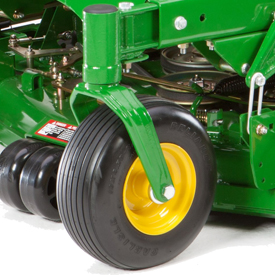 Front caster tire
Front caster tire
The ZTrak M Series Mowers with 48-in. (122-cm) mower decks come with 24x9.5-12 4 PR drive tires. M Series Mowers with 54-in. (137-cm), 60-in. (152-cm), and 72-in. (183-cm) decks come with 24x12-12 4 PR drive tires. All M Series Mowers are equipped with 13x6.5-6 front flat-free semi-pneumatic caster tires for the following:
- Excellent traction, flotation, and curb climbing
- Low center of gravity to increase hillside mowing capability
- Caster wheels and caster wheel towers with sealed bearings for long life and easy steering
- Offset front caster wheels to help improve the inside corner-trim performance and also reduce between-blade striping
Michelin, X, and Tweel are trademarks of Michelin North America, Inc.
Powerful 31-hp (23.1-kW) commercial-grade engine delivers class-leading performance and efficiency
 Z960M engine
Z960M engine

The Z960M is powered by an air-cooled, vertical shaft engine:
- 31-hp (23.1-kW) gas engine
Engine features include:
- Overhead valve design
- More horsepower and torque per cubic inch of displacement
- Better fuel efficiency
- Full-pressure lubrication with full-flow filter
- Reduces engine wear by ensuring proper lubrication, even when operating on hillsides or uneven terrain
- Oil filter helps keep oil clean for increased engine life
- V-twin big block design
- Vertical shaft
- Easy-access, dual-element air filter with quick-release latch
- 15-amp alternator
- Fuel pump
- Complies with strict Environmental Protection Agency (EPA) and California Air Resources Board (CARB) emission standards without loss of horsepower or torque
- Aluminum block engines
- Effectively dissipate heat
- Lightweight and strong construction
- Extend engine life due to elimination of debilitating engine temperatures
- Air-cooled engine design
Air cleaner filters out dust that can damage an engine
 Engine air cleaner
Engine air cleaner
 Air cleaner cover removed
Air cleaner cover removed
ZTrak™ Z900 Mowers are equipped with a dual-element, canister-style air filter, easily accessible from the rear of the machine without tools.
- The filtration system pulls clean air from above the engine, in turn filtering out the dust that can damage an engine over time.
- Filters are extremely easy to change when required.
- Pre-cleaner provides more protection against contamination in dusty and dirty applications.
Mow all day on a single tank of fuel with efficient and easy-to-fill fuel tank
 Fuel tank and filler neck
Fuel tank and filler neck
 Fuel filler neck
Fuel filler neck
The ZTrak™ Z900 Mowers are equipped with one single-fill, top-draw fuel tank:
- 11.5-U.S. gal. (43.5-L) capacity enables operators to mow all day without refueling.
- The fuel gauge makes it quick and easy to see how much fuel is in the tank.
- Top draw provides added safety.
- A large fuel-filler neck is angled to make it easy for an operator to complete the fueling process.
Under normal conditions, load, and operation, fuel consumption for the Z900 ZTrak Mowers is 1.5 U.S. gph (5.7 L/hr) to 2.2 U.S. gph (8.3 L/hr), depending on the horsepower and conditions.
Durable hydrostatic drive train that delivers better cooling and provides easy access
 Heavy-duty ground drive
Heavy-duty ground drive
The hydrostatic drive features two 13-cc (0.8-cu in.) unitized hydraulic pumps combined with commercial-grade, heavy-duty wheel motors into a single unit.
One pump and one motor drive each wheel on the ZTrak™ E and M Series Mowers. This provides several benefits:
- Exceptional cooling in high-load conditions
- Easy-to-check level and refill hydraulic oil
- Opens up access under the seat
Three seat choices with ComfortGlide™ fore/aft suspension offer exceptional operator comfort
There are three seating options available for the M Series, all of which are factory installed:
- Deluxe comfort seat with armrests
- Deluxe comfort seat with armrests and isolation
- Fully adjustable suspension seat with armrests
ComfortGlide fore/aft suspension
 ComfortGlide fore/aft suspension control lever
ComfortGlide fore/aft suspension control lever
Each seat has the ComfortGlide fore/aft suspension system that gives superior ride comfort over uneven areas:
- Seat can travel up to 2 in. (50.8 mm) fore and aft to absorb bumps for a significant enhancement to ride comfort.
- Control lever provides the ability to easily lock out fore/aft suspension movement if desired.
- One lever has three functions:
- Slide seat forward and back 3 in. (10.2 cm) to allow the operator the ability to choose the leg room needed
- Activate ComfortGlide fore/aft seat suspension
- Lock out ComfortGlide fore/aft seat suspension
Deluxe comfort seat with armrests
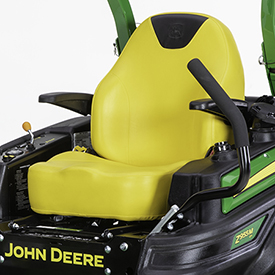 Deluxe comfort seat with armrests
Deluxe comfort seat with armrests
The deluxe comfort seat with armrests is standard on all E and M Series models:
- Rubber springs are provided to increase ride comfort.
- A convenient seat latch makes it easy to lift the seat.
- The seat is factory installed.
Deluxe comfort seat with armrests and isolation
 Deluxe comfort seat with armrests and isolation
Deluxe comfort seat with armrests and isolation
 Rubber isolation mount
Rubber isolation mount
The deluxe comfort seat with armrests and isolation is available on the E, M, and R Series:
- Rubber springs are provided to isolate the seat base and to increase ride comfort.
- A convenient seat latch makes it easy to lift the seat.
- Isolation mounting is a good feature to reduce vibration for operators who do not require the fully adjustable suspension seat option.
- Factory installed on Z900s ordered with the deluxe comfort seat with armrests and isolation option.
Fully adjustable suspension seat with armrests
 Fully adjustable, mechanical suspension-seat
Fully adjustable, mechanical suspension-seat
 Suspension seat control
Suspension seat control
A fully adjustable suspension seat with armrests option is available on the M and R Series:
- Adjustable back angle is provided for individual operator comfort.
- Adjustable lumbar support helps to suit the needs of the operator.
- A suspension seat control dial gives easy adjustment for operator weight and ride comfort.
- A convenient seat latch provides ease of lifting the seat.
- On Z900s ordered with the fully adjustable suspension seat with armrests option, it is factory installed.
Designed for operator comfort
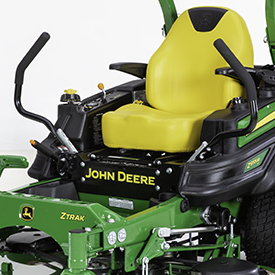 Operator station
Operator station
Two-lever hydrostatic control provides the following:
- The operator can select the ground speed and direction control simply by moving levers forward or reverse.
- Positive neutral lock position for levers provides added safety.
- Brake & Go operator-presence system returns levers to the neutral position when the brake pedal is actively engaged.
- Starting the machines is as easy as starting a car. It no longer matters if the control levers are extended out or pulled in, as long as the parking brake is engaged. Just turn the key and go.
- Wide-bend, large-diameter steering levers swing out easily for entry and exit from the operator platform.
Brake & Go starting system
 Parking brake pedal (Z900R Series)
Parking brake pedal (Z900R Series)
 Parking brake lever (Z900 E and M Series)
Parking brake lever (Z900 E and M Series)
The Brake & Go starting system is a John Deere exclusive. This feature makes the starting process on all ZTrak™ mowers easier, while also making it possible to remove two interlock switches from the machine.
The Brake & Go starting procedure helps a novice operator look and feel like a professional. To start the machine, the parking brake must be engaged. It does not matter whether the power take-off (PTO) switch is on or off, nor does it matter if the control levers are pulled in or in the out position.
As long as the parking brake is engaged, the machine will start. When the parking brake is applied, the control levers cannot be moved to the forward or reverse positions.
Adjustable levers
 Adjustable levers
Adjustable levers
The motion control levers have two height positions and can also be adjusted forward or rearward within the slotted holes. The levers should be adjusted so the operator can achieve a full range of control operation comfortably.
Tracking adjustment
 Tracking adjustment
Tracking adjustment
The easy-to-turn (from-the-seat) tracking adjustment allows operators to keep their mowers straight and produce professional striping results.
Onboard storage and cup holder
 Onboard storage
Onboard storage
 Cup holder
Cup holder
Several storage areas are provided on the ZTrak machines. A convenient cup holder is also available.
Right-hand control panel
 Right-hand control panel
Right-hand control panel
 Right-hand control panel
Right-hand control panel
The controls are grouped together on the right console, providing one central location for key switch, throttle, PTO engagement, height-of-cut, diagnostics, and hour meter.
- Rocker-type PTO switch
- Height-of-cut knob with transport lock
- Key switch
- Hourmeter
- Throttle
- Separate choke control
- Easy choke operation yields less fouling of plugs
- No choke required for the electronic fuel injection (EFI) models
Easy-to-operate height-of-cut adjustment enables on-the-go changes
 Mower deck height adjustment knob
Mower deck height adjustment knob
An easy-to-use cutting-height lift system allows the operator to adjust the mower deck height with no tools and minimal effort. The easy-to-grip knob allows operators to dial in the desired height of cut (HOC).
Cutting height can be adjusted from approximately 1 in. to 5.5 in. (2.5 cm to 14 cm). Each increment on the knob adjusts the HOC approximately 0.25 in. (0.64 cm). The deck can also be raised and locked in a transport position to provide maximum ground clearance when moving the machine from one area to another.
The transport lock function allows the deck to be returned to the previous HOC after being in the transport position:
- Use the foot-lift pedal to lift the deck and engage the transport lock.
- Rotate the knob to adjust from 1 in. to 5.5 in. (2.5 cm to 14 cm) in 0.25-in. (0.64 cm) increments.
This design increases productivity by allowing operators to change the cutting height without having to leave the seat.
Mower is easy to service with many accessible components
 Z955R EFI left front view
Z955R EFI left front view
The design of the Z900 Series makes many service components reachable and easily accessible from the ground.
- Large, open engine compartment at the rear of the machine provides convenient servicing and ensures the engine heat is directed away from the operator.
 Flip-up foot panel
Flip-up foot panel
 Flip-up seat
Flip-up seat
Onboard maintenance chart
 Maintenance chart
Maintenance chart
All ZTrak™ Mowers come with an onboard maintenance chart that is conveniently located inside the right-hand console. The service interval chart gives necessary service intervals.
Diagnostics
 Hour meter (M Series pictured)
Hour meter (M Series pictured)
 Diagnostic chart
Diagnostic chart
The hour meter shows the number of hours the machine is run when the key switch is in the on position. It only counts the hours the engine is actually running. Machine diagnostics are the first step of a monitoring system to help operators quickly diagnose common downtime issues. A trouble code light is included on the hour meter.
Use of the hour meter and service interval chart helps determine when the machine will need service.
Rollover protective structure (ROPS) enhances operator safety
 ROPS up
ROPS up
 ROPS mid position
ROPS mid position
 ROPS down position
ROPS down position
The ZTrak™ Z900E, M, and R Series Mowers are equipped with a standard two-post folding ROPS and seat belt. The folding ROPS enhances operator safety and provides ample clearance when storing the mower in garages or sheds:
- ISO21299 certification
- Foldable
The ROPS system can be repositioned without the use of tools. Under normal operation, the ROPS should be in the up position. If operating in low clearance areas, they can be folded and secured out of the way. The ROPS can also be pinned halfway down to accommodate machines equipped with a material collection system.
Three-year, bumper-to-bumper warranty
 Z955M ZTrak™ Mower
Z955M ZTrak™ Mower
 Z955R ZTrak Mower
Z955R ZTrak Mower
E and M Series 3-year, 1200-hour bumper-to-bumper warranty
An exclusive 2-year, unlimited hour/3-year, 1200-hour (whichever comes first) bumper-to-bumper warranty is standard for all John Deere E and M Series Mowers. The warranty is best in its class and places John Deere at the forefront of commercial mowing. It is also hassle free, with one company handling all of the paperwork.
NOTE: 36 months or 1200 hours, whichever comes first. For the first 24 months, there is no hour limitation.
R Series 3-year, 1500-hour bumper-to-bumper warranty
An exclusive 2-year, unlimited hour/3-year, 1500-hour (whichever comes first) bumper-to-bumper warranty is standard on all John Deere R Series mowers. The warranty is best in the industry and puts John Deere at the forefront of commercial mowing. It is also hassle free, with one company handling all of the paperwork.
NOTE: 36 months or 1500 hours, whichever comes first. For the first 24 months, there is no hour limitation.
Mower decks are safety certified
 Z950M ZTrak Mower
Z950M ZTrak Mower
Mowers decks are evaluated by the manufacturer (John Deere Turf Care) and conform to American National Standards Institute (ANSI) B71.4 2004 safety certification specifications for commercial turf care equipment.
Durable 7-Iron™ PRO decks pressed from a single piece of steel
 72-in. (183-cm) 7-Iron PRO deck shown
72-in. (183-cm) 7-Iron PRO deck shown
The ZTrak™ M and R Series Mowers are equipped with either a side-discharge or Mulch On Demand™ 7-Iron PRO deck.
7-Iron PRO mower decks have demonstrated quality, performance, and durability. They deliver a high quality cut in diverse conditions.
Key features of the 7-Iron PRO mower deck:
- Deck is stamped from 7-gauge, 0.179-in. (4.6-mm) steel to minimize the number of welds and provide a smooth underside with fewer sharp corners for reduced material buildup.
- Significantly fewer welds on the deck shell to wear or break - it is stamped from a single sheet of steel rather than multiple fabrications. An anti-skid step on the deck provides easy machine mounting.
- Higher blade tip speed than many competitors - 18,500 fpm (5,639 m/min) for more blade cuts per inch mowed.
- A deep-deck design of 5.5 in. (14 cm) delivers excellent airflow so material can be processed quickly and efficiently.
- The wider and higher discharge opening provides even clipping dispersal for an excellent finished appearance in all conditions.
 Mower rectangular leading-edge reinforcement
Mower rectangular leading-edge reinforcement
 Dual-captured anti-scalp wheel
Dual-captured anti-scalp wheel
Key features of the 7-Iron PRO mower deck:
- Deck has rectangular leading deck edge reinforcement and the rounded corners of the stamped deck help distribute impact stress to reduce the potential of damage when the mower contacts trees, rocks, curbs, and other fixed obstacles.
- Dual-captured front and rear anti-scalp wheels provide deck flotation over even the toughest terrain.
- Three 1-in. (2.5-cm), cold-forged spindles are heat-treated for strength without bulk and are supported by ball bearings, providing reliability and performance; spindle housings are ribbed cast aluminum providing both excellent strength and heat dissipation.
- The front edge is raised above the blade plane to allow even cutting of tall grass and is reinforced with a square bar for durability. The front baffle has been redesigned to better manage airflow and control clippings.
- Three spindle grease fittings are accessible from the top.
- Blade overlap is 1.6 in. (40.6 mm), nearly 0.79 in. (20 mm) greater than previous decks, to reduce striping between blades.
- Quick-change, cutting-height adjustment.
7-Iron PRO mower deck
| M Series | R Series |
| Z920M - 48 in. (122 cm), 54 in. (137 cm), 60 in. (152 cm) | Z930R - 54 in. (137 cm), 60 in. (152 cm) |
| Z930M - 54 in. (137 cm), 60 in. (152 cm) | Z950R - 60 in. (152 cm), 72 in. (183 cm) |
| Z945M EFI - 60 in. (152 cm) | Z955R EFI - 60 in. (152 cm) |
| Z950M - 60 in. (152 cm), 72 in. (183 cm) | Z970R - 60 in. (152 cm), 72 in. (183 cm) |
| Z955M EFI - 60 in. (152 cm), 72 in. (183 cm) | |
| Z960M - 60 in. (152 cm), 72 in. (183 cm) |
 Mower deck step shown on 72-in. (183-cm) mower
Mower deck step shown on 72-in. (183-cm) mower
The deck step safely aids the operator's entrance and egress from machine.
Available Mulch On Demand™ deck
 Mulch On Demand mower deck
Mulch On Demand mower deck
 Mower deck with chute closed
Mower deck with chute closed
The Mulch On Demand mower deck delivers unprecedented levels of productivity and versatility to commercial mower operation. With the ability to switch between side discharge and mulching operation with the flip of a lever as the operator mows, keeping most clippings out of landscaping features and where they are wanted is extremely easy.
 Mulch On Demand open
Mulch On Demand open
![Mulch On Demand closed (latch standard on material collection system [MCS] equipped models only)](https://salesmanual.deere.com/sales/salesmanual/images/NA/commercial_mowers/features_attachment/ztraks_com/480295_mod_deck_oval_275x175.jpg) Mulch On Demand closed (latch standard on material collection system [MCS] equipped models only)
Mulch On Demand closed (latch standard on material collection system [MCS] equipped models only)
 Lever position open (latch standard on MCS-equipped models only)
Lever position open (latch standard on MCS-equipped models only)
 Lever position closed
Lever position closed
Key features of the 7-Iron™ PRO Mulch On Demand mower deck:
- Deck can be converted from a wide-open side discharge mode to a fully chambered mulching mode with a single move of a lever.
- NOTE: Mulch On Demand decks are a balance between a side discharge deck and a side discharge deck with a mulching kit.
- Deck is stamped from 7-gauge, 0.179-in. (4.6-mm) steel to minimize the number of welds and provide a smooth underside, with fewer sharp corners, for reduced material buildup.
- Significantly fewer welds on the deck shell to wear or break- it is stamped from a single sheet of steel rather than multiple fabrications. Anti-skid step on the deck provides for easy machine mounting.
- Mulch On Demand decks are superior to aftermarket chute blockers due to the movable baffles.
- Higher blade tip speed than many competitors - 18,500 fpm (5,639 m/min) for more blade cuts per inch mowed.
- Rounded corners of the stamped deck help distribute impact stress to reduce the potential of damage when the mower contacts trees, rocks, curbs, and other fixed obstacles.
- Deep-deck design of 5.5 in. (14 cm) delivers excellent airflow so material can be processed quickly and efficiently.
- Wider and higher discharge opening provides even clipping dispersal for an excellent finished appearance in all conditions.
- Three 1-in. (2.5 cm) cold-forged spindles are heat-treated for strength without bulk and are supported by ball bearings, providing reliability and performance; spindle housings are ribbed cast aluminum providing both excellent strength and heat dissipation.
- The front edge is raised above the blade plane to allow even cutting of tall grass and reinforced with a square bar for durability. The front baffle has been redesigned to better manage airflow and control clippings.
- Dual-captured anti-scalp wheels provide deck flotation over even the toughest terrain.
- Three greasable spindle zerks accessible from the top.
- Blade overlap is 1.6 in. (40 mm), nearly 0.79 in. (20 mm) greater than previous decks, to reduce striping between blades.
- Quick-change, cutting-height adjustment.
7-Iron PRO Mulch On Demand mower deck
| M Series | R Series |
| Z920M - 48-in. (122-cm) Mulch On Demand | Z930R - 54-in. (137-cm) Mulch On Demand |
| Z930M - 54-in. (137-cm) Mulch On Demand Z930M - 60-in. (152-cm) Mulch On Demand |
Z950R - 60-in. (152-cm) Mulch On Demand |
| Z945M EFI - 60-in. (152-cm) Mulch On Demand | Z970R - 60-in. (152-cm) Mulch On Demand |
| Z950M - 60-in. (152-cm) Mulch On Demand | |
| Z955M EFI - 60-in. (152-cm) Mulch On Demand | |
| Z960M - 60-in. (152-cm) Mulch On Demand |
Spindle assembly provides greater performance and reliability
 Spindle assembly
Spindle assembly
On every John Deere ZTrak™ mower deck, there are three 1-in. (2.5-cm) spindles that are cold-forged and heat-treated for strength without bulk. The spindles are supported by precision ball bearings, providing great performance and reliability.
The spindle housing is made of aircraft-grade, ribbed cast aluminum. This unique casting design embosses reinforcing gussets in the housing, which adds both strength and cooling surface area that stands up to commercial applications.
These spindles can be greased from the top and require no disassembly to reach. Grease channels provide lubrication to both bearings.
Features
Heavy-duty frame provides strength and durability
 Z955R EFI model shown with optional X® Tweel® Turf airless radial tire technology
Z955R EFI model shown with optional X® Tweel® Turf airless radial tire technology

The durability features of the frame are as follows:
-
Heavy-duty, thick-gauge, steel channel mainframe for strength and durability
-
Cast I-beam caster arms to handle the beating and pounding professional mowers receive
-
Wide-open access for maintenance and cleaning
Two-piece rear bumper provides protection
 Illustration of ZTrak™ mower rear bumper
Illustration of ZTrak™ mower rear bumper
A steel rear bumper provides protection for the machine. The bumper is made of two pieces, making it easy to remove and install when using a material collection system (MCS).
A rear hitch can be added to the steel bumper for towing purposes. ZTrak E, M, and R Series Mowers can tow up to 400 lb (181.4 kg).
Michelin, X, and Tweel are trademarks of Michelin North America, Inc.
Michelin® X® Tweel® Turf airless radial tire technology for ZTrak™ Mowers eliminates downtime and reduces cost of operation
 Flat-free rear tire shown on ZTrak™ Mower
Flat-free rear tire shown on ZTrak™ Mower
John Deere provides the commercial mower industry with the Michelin X Tweel Turf technology for Commercial ZTrak Mowers:
- 24x12N12 as an ordering option code for ZTrak Gas Mowers with 54 in., 60 in., and 72 in. (137-cm, 152-cm, and 183-cm) Mower Decks
- 24x12N12 is also available as base code equipment for ZTrak Gas Mowers with 54 in., 60 in., and 72 in. (137-cm, 152-cm, and 183-cm) Mower Decks (ordering information available at Configurator on the Tweel model page)
- 24x12N12 as an ordering option code for ZTrak Z994R Diesel with 54 in., 60 in., and 72 in. (137-cm, 152-cm, and 183 cm) Mower Decks
- 26x12N12 as an ordering option code for Z997R Diesel with 60 in. and 72 in. (152-cm and 183-cm) Mower Decks
Michelin is a world leader in tire manufacturing and technology. This airless radial tire solution is an industry first for John Deere, which provides an additional advantage to John Deere customers.
Advantages of the Michelin X Tweel Turf include:
- Mowing performance is improved.
- Rutting is reduced because the Michelin X Tweel Turf has more support across the surface for improved flotation and better ground contact.
- Unique energy transfer within the poly-resin spokes reduces the bounce associated with pneumatic tires.
- Excellent curb climbing is possible due to the Michelin X Tweel Turf construction and flexibility.
- More consistent cut quality is achieved because inconsistent tire pressure is eliminated.
- Uptime is improved.
- The exclusive technology eliminates downtime and associated cost due to flat or damaged tires.
- Punctures and sidewall damage no longer result in downtime.
- Cost of operation is reduced.
- Cost of repairs and maintenance is reduced. One single unit replaces the current tire, wheel, and valve assembly. There is no need for complex tire-mounting equipment.
- No need to spend time checking and optimizing tire pressure.
- The need to purchase and stock plug kits and spare tires is eliminated, particularly for professional landscape contractors and government agencies who normally stock them.
- The tire tread will last up to three times longer than current pneumatic tires because automotive-grade rubber is used for the tread.
 Michelin X Tweel Turf
Michelin X Tweel Turf
 Michelin X Tweel Turf
Michelin X Tweel Turf
Heavy-duty construction provides the ultimate in performance and reliable operation:
- High-strength poly-resin spokes carry the load.
- Four-hole, heavy-duty steel hub for durability.
- Deep, open-tread design provides excellent cleaning and traction.
- Zero degree, high-tensile proprietary carcass provides great lateral stiffness while resisting damage from impact and penetration.
NOTE: In some cases, different size Tweel tires are required depending on the mower deck size.
Tires deliver exceptional traction and maneuverability
 Drive tire
Drive tire
 Front caster tire
Front caster tire
The ZTrak M Series Mowers with 48-in. (122-cm) mower decks come with 24x9.5-12 4 PR drive tires. M Series Mowers with 54-in. (137-cm), 60-in. (152-cm), and 72-in. (183-cm) decks come with 24x12-12 4 PR drive tires. All M Series Mowers are equipped with 13x6.5-6 front flat-free semi-pneumatic caster tires for the following:
- Excellent traction, flotation, and curb climbing
- Low center of gravity to increase hillside mowing capability
- Caster wheels and caster wheel towers with sealed bearings for long life and easy steering
- Offset front caster wheels to help improve the inside corner-trim performance and also reduce between-blade striping
Michelin, X, and Tweel are trademarks of Michelin North America, Inc.
Powerful 29-hp (21.6-kW) commercial-grade, electronically-fuel-injected engine delivers class-leading performance and efficiency
 Electronic fuel injection (EFI) engine
Electronic fuel injection (EFI) engine
Get power, performance, and efficiency from the air-cooled, vertical shaft, EFI gas engine with 29 hp (21.6 kW).
Engine features include:
- Electronic, closed-loop electronic fuel injection system with oxygen sensor
- Up to 25 percent better fuel economy than typical carbureted engines of similar power
- Cleaner emissions
- Easier starting No choke control or cable
- Better recovery under load
- Automatic optimization for altitude (air pressure), air temperature, engine temperature, and fuel blends up to E10
- Onboard diagnostics (blink codes) and plug-in diagnostics (Service ADVISOR™ system) for EFI system trouble codes
- Overhead valve design
- More horsepower and torque per cubic inch of displacement
- Better fuel efficiency
- Full-pressure lubrication with full-flow filter
- Reduces engine wear by ensuring proper lubrication, even when operating on hillsides or uneven terrain
- Oil filter helps keep oil clean for increased engine life
- V-twin big block design
- Vertical shaft
- Easy-access, dual-element air filter
- 20-amp alternator
- Electric fuel pump
- Complies with strict U.S. Environmental Protection Agency (EPA) emission standards without loss of horsepower or torque
- Aluminum block engines
- Effectively dissipate heat
- Lightweight and strong construction
- Extend engine life due to elimination of debilitating engine temperatures
- Air-cooled engine design
Air cleaner filters out dust that can damage an engine
 Engine air cleaner
Engine air cleaner
 Air cleaner cover removed
Air cleaner cover removed
ZTrak™ Z900 Mowers are equipped with a dual-element, canister-style air filter, easily accessible from the rear of the machine without tools.
- The filtration system pulls clean air from above the engine, in turn filtering out the dust that can damage an engine over time.
- Filters are extremely easy to change when required.
- Pre-cleaner provides more protection against contamination in dusty and dirty applications.
Mow all day on a single tank of fuel with efficient and easy-to-fill fuel tank
 Fuel tank and filler neck
Fuel tank and filler neck
 Fuel filler neck
Fuel filler neck
The ZTrak™ Z900 Mowers are equipped with one single-fill, top-draw fuel tank:
- 11.5-U.S. gal. (43.5-L) capacity enables operators to mow all day without refueling.
- The fuel gauge makes it quick and easy to see how much fuel is in the tank.
- Top draw provides added safety.
- A large fuel-filler neck is angled to make it easy for an operator to complete the fueling process.
Under normal conditions, load, and operation, fuel consumption for the Z900 ZTrak Mowers is 1.5 U.S. gph (5.7 L/hr) to 2.2 U.S. gph (8.3 L/hr), depending on the horsepower and conditions.
Durable hydrostatic drive train that delivers better cooling and provides easy access
 Heavy-duty ground drive
Heavy-duty ground drive
The hydrostatic drive features two 13-cc (0.8-cu in.) unitized hydraulic pumps combined with commercial-grade, heavy-duty wheel motors into a single unit.
One pump and one motor drive each wheel on the ZTrak™ E and M Series Mowers. This provides several benefits:
- Exceptional cooling in high-load conditions
- Easy-to-check level and refill hydraulic oil
- Opens up access under the seat
Three seat choices with ComfortGlide™ fore/aft suspension offer exceptional operator comfort
There are three seating options available for the M Series, all of which are factory installed:
- Deluxe comfort seat with armrests
- Deluxe comfort seat with armrests and isolation
- Fully adjustable suspension seat with armrests
ComfortGlide fore/aft suspension
 ComfortGlide fore/aft suspension control lever
ComfortGlide fore/aft suspension control lever
Each seat has the ComfortGlide fore/aft suspension system that gives superior ride comfort over uneven areas:
- Seat can travel up to 2 in. (50.8 mm) fore and aft to absorb bumps for a significant enhancement to ride comfort.
- Control lever provides the ability to easily lock out fore/aft suspension movement if desired.
- One lever has three functions:
- Slide seat forward and back 3 in. (10.2 cm) to allow the operator the ability to choose the leg room needed
- Activate ComfortGlide fore/aft seat suspension
- Lock out ComfortGlide fore/aft seat suspension
Deluxe comfort seat with armrests
 Deluxe comfort seat with armrests
Deluxe comfort seat with armrests
The deluxe comfort seat with armrests is standard on all E and M Series models:
- Rubber springs are provided to increase ride comfort.
- A convenient seat latch makes it easy to lift the seat.
- The seat is factory installed.
Deluxe comfort seat with armrests and isolation
 Deluxe comfort seat with armrests and isolation
Deluxe comfort seat with armrests and isolation
 Rubber isolation mount
Rubber isolation mount
The deluxe comfort seat with armrests and isolation is available on the E, M, and R Series:
- Rubber springs are provided to isolate the seat base and to increase ride comfort.
- A convenient seat latch makes it easy to lift the seat.
- Isolation mounting is a good feature to reduce vibration for operators who do not require the fully adjustable suspension seat option.
- Factory installed on Z900s ordered with the deluxe comfort seat with armrests and isolation option.
Fully adjustable suspension seat with armrests
 Fully adjustable, mechanical suspension-seat
Fully adjustable, mechanical suspension-seat
 Suspension seat control
Suspension seat control
A fully adjustable suspension seat with armrests option is available on the M and R Series:
- Adjustable back angle is provided for individual operator comfort.
- Adjustable lumbar support helps to suit the needs of the operator.
- A suspension seat control dial gives easy adjustment for operator weight and ride comfort.
- A convenient seat latch provides ease of lifting the seat.
- On Z900s ordered with the fully adjustable suspension seat with armrests option, it is factory installed.
Designed for operator comfort
 Operator station
Operator station
Two-lever hydrostatic control provides the following:
- The operator can select the ground speed and direction control simply by moving levers forward or reverse.
- Positive neutral lock position for levers provides added safety.
- Brake & Go operator-presence system returns levers to the neutral position when the brake pedal is actively engaged.
- Starting the machines is as easy as starting a car. It no longer matters if the control levers are extended out or pulled in, as long as the parking brake is engaged. Just turn the key and go.
- Wide-bend, large-diameter steering levers swing out easily for entry and exit from the operator platform.
Onboard storage and cup holder
 Onboard storage
Onboard storage
 Cup holder
Cup holder
Several storage areas are provided on the ZTrak machines. A convenient cup holder is also available.
Brake & Go starting system
 Parking brake pedal (Z900R Series)
Parking brake pedal (Z900R Series)
 Parking brake lever (Z900 E and M Series)
Parking brake lever (Z900 E and M Series)
The Brake & Go starting system is a John Deere exclusive. This feature makes the starting process on all ZTrak™ mowers easier, while also making it possible to remove two interlock switches from the machine.
The Brake & Go starting procedure helps a novice operator look and feel like a professional. To start the machine, the parking brake must be engaged. It does not matter whether the power take-off (PTO) switch is on or off, nor does it matter if the control levers are pulled in or in the out position.
As long as the parking brake is engaged, the machine will start. When the parking brake is applied, the control levers cannot be moved to the forward or reverse positions.
Adjustable levers
 Adjustable levers
Adjustable levers
The motion control levers have two height positions and can also be adjusted forward or rearward within the slotted holes. The levers should be adjusted so the operator can achieve a full range of control operation comfortably.
Tracking adjustment
 Tracking adjustment
Tracking adjustment
The easy-to-turn (from-the-seat) tracking adjustment allows operators to keep their mowers straight and produce professional striping results.
Right-hand control panel
 Right-hand control panel
Right-hand control panel
 Right-hand control panel
Right-hand control panel
The controls are grouped together on the right console, providing one central location for key switch, throttle, PTO engagement, height-of-cut, diagnostics, and hour meter.
- Rocker-type PTO switch
- Height-of-cut knob with transport lock
- Key switch
- Hourmeter
- Throttle
- Separate choke control
- Easy choke operation yields less fouling of plugs
- No choke required for the electronic fuel injection (EFI) models
Easy-to-operate height-of-cut adjustment enables on-the-go changes
 Mower deck height adjustment knob
Mower deck height adjustment knob
An easy-to-use cutting-height lift system allows the operator to adjust the mower deck height with no tools and minimal effort. The easy-to-grip knob allows operators to dial in the desired height of cut (HOC).
Cutting height can be adjusted from approximately 1 in. to 5.5 in. (2.5 cm to 14 cm). Each increment on the knob adjusts the HOC approximately 0.25 in. (0.64 cm). The deck can also be raised and locked in a transport position to provide maximum ground clearance when moving the machine from one area to another.
The transport lock function allows the deck to be returned to the previous HOC after being in the transport position:
- Use the foot-lift pedal to lift the deck and engage the transport lock.
- Rotate the knob to adjust from 1 in. to 5.5 in. (2.5 cm to 14 cm) in 0.25-in. (0.64 cm) increments.
This design increases productivity by allowing operators to change the cutting height without having to leave the seat.
Mower is easy to service with many accessible components
 Z955R EFI left front view
Z955R EFI left front view
The design of the Z900 Series makes many service components reachable and easily accessible from the ground.
- Large, open engine compartment at the rear of the machine provides convenient servicing and ensures the engine heat is directed away from the operator.
 Flip-up foot panel
Flip-up foot panel
 Flip-up seat
Flip-up seat
Onboard maintenance chart
 Maintenance chart
Maintenance chart
All ZTrak™ Mowers come with an onboard maintenance chart that is conveniently located inside the right-hand console. The service interval chart gives necessary service intervals.
Diagnostics
 Hour meter (M Series pictured)
Hour meter (M Series pictured)
 Diagnostic chart
Diagnostic chart
The hour meter shows the number of hours the machine is run when the key switch is in the on position. It only counts the hours the engine is actually running. Machine diagnostics are the first step of a monitoring system to help operators quickly diagnose common downtime issues. A trouble code light is included on the hour meter.
Use of the hour meter and service interval chart helps determine when the machine will need service.
Rollover protective structure (ROPS) enhances operator safety
 ROPS up
ROPS up
 ROPS mid position
ROPS mid position
 ROPS down position
ROPS down position
The ZTrak™ Z900E, M, and R Series Mowers are equipped with a standard two-post folding ROPS and seat belt. The folding ROPS enhances operator safety and provides ample clearance when storing the mower in garages or sheds:
- ISO21299 certification
- Foldable
The ROPS system can be repositioned without the use of tools. Under normal operation, the ROPS should be in the up position. If operating in low clearance areas, they can be folded and secured out of the way. The ROPS can also be pinned halfway down to accommodate machines equipped with a material collection system.
Three-year, bumper-to-bumper warranty
 Z955M ZTrak™ Mower
Z955M ZTrak™ Mower
 Z955R ZTrak Mower
Z955R ZTrak Mower
E and M Series 3-year, 1200-hour bumper-to-bumper warranty
An exclusive 2-year, unlimited hour/3-year, 1200-hour (whichever comes first) bumper-to-bumper warranty is standard for all John Deere E and M Series Mowers. The warranty is best in its class and places John Deere at the forefront of commercial mowing. It is also hassle free, with one company handling all of the paperwork.
NOTE: 36 months or 1200 hours, whichever comes first. For the first 24 months, there is no hour limitation.
R Series 3-year, 1500-hour bumper-to-bumper warranty
An exclusive 2-year, unlimited hour/3-year, 1500-hour (whichever comes first) bumper-to-bumper warranty is standard on all John Deere R Series mowers. The warranty is best in the industry and puts John Deere at the forefront of commercial mowing. It is also hassle free, with one company handling all of the paperwork.
NOTE: 36 months or 1500 hours, whichever comes first. For the first 24 months, there is no hour limitation.
Mower decks are safety certified
 Z950M ZTrak Mower
Z950M ZTrak Mower
Mowers decks are evaluated by the manufacturer (John Deere Turf Care) and conform to American National Standards Institute (ANSI) B71.4 2004 safety certification specifications for commercial turf care equipment.
Durable 7-Iron™ PRO decks pressed from a single piece of steel
 72-in. (183-cm) 7-Iron PRO deck shown
72-in. (183-cm) 7-Iron PRO deck shown
The ZTrak™ M and R Series Mowers are equipped with either a side-discharge or Mulch On Demand™ 7-Iron PRO deck.
7-Iron PRO mower decks have demonstrated quality, performance, and durability. They deliver a high quality cut in diverse conditions.
Key features of the 7-Iron PRO mower deck:
- Deck is stamped from 7-gauge, 0.179-in. (4.6-mm) steel to minimize the number of welds and provide a smooth underside with fewer sharp corners for reduced material buildup.
- Significantly fewer welds on the deck shell to wear or break - it is stamped from a single sheet of steel rather than multiple fabrications. An anti-skid step on the deck provides easy machine mounting.
- Higher blade tip speed than many competitors - 18,500 fpm (5,639 m/min) for more blade cuts per inch mowed.
- A deep-deck design of 5.5 in. (14 cm) delivers excellent airflow so material can be processed quickly and efficiently.
- The wider and higher discharge opening provides even clipping dispersal for an excellent finished appearance in all conditions.
 Mower rectangular leading-edge reinforcement
Mower rectangular leading-edge reinforcement
 Dual-captured anti-scalp wheel
Dual-captured anti-scalp wheel
Key features of the 7-Iron PRO mower deck:
- Deck has rectangular leading deck edge reinforcement and the rounded corners of the stamped deck help distribute impact stress to reduce the potential of damage when the mower contacts trees, rocks, curbs, and other fixed obstacles.
- Dual-captured front and rear anti-scalp wheels provide deck flotation over even the toughest terrain.
- Three 1-in. (2.5-cm), cold-forged spindles are heat-treated for strength without bulk and are supported by ball bearings, providing reliability and performance; spindle housings are ribbed cast aluminum providing both excellent strength and heat dissipation.
- The front edge is raised above the blade plane to allow even cutting of tall grass and is reinforced with a square bar for durability. The front baffle has been redesigned to better manage airflow and control clippings.
- Three spindle grease fittings are accessible from the top.
- Blade overlap is 1.6 in. (40.6 mm), nearly 0.79 in. (20 mm) greater than previous decks, to reduce striping between blades.
- Quick-change, cutting-height adjustment.
7-Iron PRO mower deck
| M Series | R Series |
| Z920M - 48 in. (122 cm), 54 in. (137 cm), 60 in. (152 cm) | Z930R - 54 in. (137 cm), 60 in. (152 cm) |
| Z930M - 54 in. (137 cm), 60 in. (152 cm) | Z950R - 60 in. (152 cm), 72 in. (183 cm) |
| Z945M EFI - 60 in. (152 cm) | Z955R EFI - 60 in. (152 cm) |
| Z950M - 60 in. (152 cm), 72 in. (183 cm) | Z970R - 60 in. (152 cm), 72 in. (183 cm) |
| Z955M EFI - 60 in. (152 cm), 72 in. (183 cm) | |
| Z960M - 60 in. (152 cm), 72 in. (183 cm) |
 Mower deck step shown on 72-in. (183-cm) mower
Mower deck step shown on 72-in. (183-cm) mower
The deck step safely aids the operator's entrance and egress from machine.
Available Mulch On Demand™ deck
 Mulch On Demand mower deck
Mulch On Demand mower deck
 Mower deck with chute closed
Mower deck with chute closed
The Mulch On Demand mower deck delivers unprecedented levels of productivity and versatility to commercial mower operation. With the ability to switch between side discharge and mulching operation with the flip of a lever as the operator mows, keeping most clippings out of landscaping features and where they are wanted is extremely easy.
 Mulch On Demand open
Mulch On Demand open
![Mulch On Demand closed (latch standard on material collection system [MCS] equipped models only)](https://salesmanual.deere.com/sales/salesmanual/images/NA/commercial_mowers/features_attachment/ztraks_com/480295_mod_deck_oval_275x175.jpg) Mulch On Demand closed (latch standard on material collection system [MCS] equipped models only)
Mulch On Demand closed (latch standard on material collection system [MCS] equipped models only)
 Lever position open (latch standard on MCS-equipped models only)
Lever position open (latch standard on MCS-equipped models only)
 Lever position closed
Lever position closed
Key features of the 7-Iron™ PRO Mulch On Demand mower deck:
- Deck can be converted from a wide-open side discharge mode to a fully chambered mulching mode with a single move of a lever.
- NOTE: Mulch On Demand decks are a balance between a side discharge deck and a side discharge deck with a mulching kit.
- Deck is stamped from 7-gauge, 0.179-in. (4.6-mm) steel to minimize the number of welds and provide a smooth underside, with fewer sharp corners, for reduced material buildup.
- Significantly fewer welds on the deck shell to wear or break- it is stamped from a single sheet of steel rather than multiple fabrications. Anti-skid step on the deck provides for easy machine mounting.
- Mulch On Demand decks are superior to aftermarket chute blockers due to the movable baffles.
- Higher blade tip speed than many competitors - 18,500 fpm (5,639 m/min) for more blade cuts per inch mowed.
- Rounded corners of the stamped deck help distribute impact stress to reduce the potential of damage when the mower contacts trees, rocks, curbs, and other fixed obstacles.
- Deep-deck design of 5.5 in. (14 cm) delivers excellent airflow so material can be processed quickly and efficiently.
- Wider and higher discharge opening provides even clipping dispersal for an excellent finished appearance in all conditions.
- Three 1-in. (2.5 cm) cold-forged spindles are heat-treated for strength without bulk and are supported by ball bearings, providing reliability and performance; spindle housings are ribbed cast aluminum providing both excellent strength and heat dissipation.
- The front edge is raised above the blade plane to allow even cutting of tall grass and reinforced with a square bar for durability. The front baffle has been redesigned to better manage airflow and control clippings.
- Dual-captured anti-scalp wheels provide deck flotation over even the toughest terrain.
- Three greasable spindle zerks accessible from the top.
- Blade overlap is 1.6 in. (40 mm), nearly 0.79 in. (20 mm) greater than previous decks, to reduce striping between blades.
- Quick-change, cutting-height adjustment.
7-Iron PRO Mulch On Demand mower deck
| M Series | R Series |
| Z920M - 48-in. (122-cm) Mulch On Demand | Z930R - 54-in. (137-cm) Mulch On Demand |
| Z930M - 54-in. (137-cm) Mulch On Demand Z930M - 60-in. (152-cm) Mulch On Demand |
Z950R - 60-in. (152-cm) Mulch On Demand |
| Z945M EFI - 60-in. (152-cm) Mulch On Demand | Z970R - 60-in. (152-cm) Mulch On Demand |
| Z950M - 60-in. (152-cm) Mulch On Demand | |
| Z955M EFI - 60-in. (152-cm) Mulch On Demand | |
| Z960M - 60-in. (152-cm) Mulch On Demand |
Spindle assembly provides greater performance and reliability
 Spindle assembly
Spindle assembly
On every John Deere ZTrak™ mower deck, there are three 1-in. (2.5-cm) spindles that are cold-forged and heat-treated for strength without bulk. The spindles are supported by precision ball bearings, providing great performance and reliability.
The spindle housing is made of aircraft-grade, ribbed cast aluminum. This unique casting design embosses reinforcing gussets in the housing, which adds both strength and cooling surface area that stands up to commercial applications.
These spindles can be greased from the top and require no disassembly to reach. Grease channels provide lubrication to both bearings.
Features
Heavy-duty frame provides strength and durability
 Z955R EFI model shown with optional X® Tweel® Turf airless radial tire technology
Z955R EFI model shown with optional X® Tweel® Turf airless radial tire technology

The durability features of the frame are as follows:
-
Heavy-duty, thick-gauge, steel channel mainframe for strength and durability
-
Cast I-beam caster arms to handle the beating and pounding professional mowers receive
-
Wide-open access for maintenance and cleaning
Two-piece rear bumper provides protection
 Illustration of ZTrak™ mower rear bumper
Illustration of ZTrak™ mower rear bumper
A steel rear bumper provides protection for the machine. The bumper is made of two pieces, making it easy to remove and install when using a material collection system (MCS).
A rear hitch can be added to the steel bumper for towing purposes. ZTrak E, M, and R Series Mowers can tow up to 400 lb (181.4 kg).
Michelin, X, and Tweel are trademarks of Michelin North America, Inc.
Michelin® X® Tweel® Turf airless radial tire technology for ZTrak™ Mowers eliminates downtime and reduces cost of operation
 Flat-free rear tire shown on ZTrak™ Mower
Flat-free rear tire shown on ZTrak™ Mower
John Deere provides the commercial mower industry with the Michelin X Tweel Turf technology for Commercial ZTrak Mowers:
- 24x12N12 as an ordering option code for ZTrak Gas Mowers with 54 in., 60 in., and 72 in. (137-cm, 152-cm, and 183-cm) Mower Decks
- 24x12N12 is also available as base code equipment for ZTrak Gas Mowers with 54 in., 60 in., and 72 in. (137-cm, 152-cm, and 183-cm) Mower Decks (ordering information available at Configurator on the Tweel model page)
- 24x12N12 as an ordering option code for ZTrak Z994R Diesel with 54 in., 60 in., and 72 in. (137-cm, 152-cm, and 183 cm) Mower Decks
- 26x12N12 as an ordering option code for Z997R Diesel with 60 in. and 72 in. (152-cm and 183-cm) Mower Decks
Michelin is a world leader in tire manufacturing and technology. This airless radial tire solution is an industry first for John Deere, which provides an additional advantage to John Deere customers.
Advantages of the Michelin X Tweel Turf include:
- Mowing performance is improved.
- Rutting is reduced because the Michelin X Tweel Turf has more support across the surface for improved flotation and better ground contact.
- Unique energy transfer within the poly-resin spokes reduces the bounce associated with pneumatic tires.
- Excellent curb climbing is possible due to the Michelin X Tweel Turf construction and flexibility.
- More consistent cut quality is achieved because inconsistent tire pressure is eliminated.
- Uptime is improved.
- The exclusive technology eliminates downtime and associated cost due to flat or damaged tires.
- Punctures and sidewall damage no longer result in downtime.
- Cost of operation is reduced.
- Cost of repairs and maintenance is reduced. One single unit replaces the current tire, wheel, and valve assembly. There is no need for complex tire-mounting equipment.
- No need to spend time checking and optimizing tire pressure.
- The need to purchase and stock plug kits and spare tires is eliminated, particularly for professional landscape contractors and government agencies who normally stock them.
- The tire tread will last up to three times longer than current pneumatic tires because automotive-grade rubber is used for the tread.
 Michelin X Tweel Turf
Michelin X Tweel Turf
 Michelin X Tweel Turf
Michelin X Tweel Turf
Heavy-duty construction provides the ultimate in performance and reliable operation:
- High-strength poly-resin spokes carry the load.
- Four-hole, heavy-duty steel hub for durability.
- Deep, open-tread design provides excellent cleaning and traction.
- Zero degree, high-tensile proprietary carcass provides great lateral stiffness while resisting damage from impact and penetration.
NOTE: In some cases, different size Tweel tires are required depending on the mower deck size.
Tires deliver exceptional traction and maneuverability
 Drive tire
Drive tire
 Front caster tire
Front caster tire
The ZTrak M Series Mowers with 48-in. (122-cm) mower decks come with 24x9.5-12 4 PR drive tires. M Series Mowers with 54-in. (137-cm), 60-in. (152-cm), and 72-in. (183-cm) decks come with 24x12-12 4 PR drive tires. All M Series Mowers are equipped with 13x6.5-6 front flat-free semi-pneumatic caster tires for the following:
- Excellent traction, flotation, and curb climbing
- Low center of gravity to increase hillside mowing capability
- Caster wheels and caster wheel towers with sealed bearings for long life and easy steering
- Offset front caster wheels to help improve the inside corner-trim performance and also reduce between-blade striping
Michelin, X, and Tweel are trademarks of Michelin North America, Inc.
Powerful 27-hp (20.1-kW) commercial-grade engine delivers class-leading performance and efficiency
 Z950M and Z950R engine
Z950M and Z950R engine

The Z950M and Z950R are powered by an air-cooled, vertical shaft engine:
- 27-hp (20.1-kW) gas engine
Engine features include:
- Overhead valve design
- More horsepower and torque per cubic inch of displacement
- Better fuel efficiency
- Full-pressure lubrication with full-flow filter
- Reduces engine wear by ensuring proper lubrication, even when operating on hillsides or uneven terrain
- Oil filter helps keep oil clean for increased engine life
- V-twin big block design
- Vertical shaft
- Easy-access, dual-element air filter with quick-release latch
- 15-amp alternator
- Fuel pump
- Complies with strict Environmental Protection Agency (EPA) and California Air Resources Board (CARB) emission standards without loss of horsepower or torque
- Aluminum block engines
- Effectively dissipate heat
- Lightweight and strong construction
- Extend engine life due to elimination of debilitating engine temperatures
- Air-cooled engine design
Air cleaner filters out dust that can damage an engine
 Engine air cleaner
Engine air cleaner
 Air cleaner cover removed
Air cleaner cover removed
ZTrak™ Z900 Mowers are equipped with a dual-element, canister-style air filter, easily accessible from the rear of the machine without tools.
- The filtration system pulls clean air from above the engine, in turn filtering out the dust that can damage an engine over time.
- Filters are extremely easy to change when required.
- Pre-cleaner provides more protection against contamination in dusty and dirty applications.
Mow all day on a single tank of fuel with efficient and easy-to-fill fuel tank
 Fuel tank and filler neck
Fuel tank and filler neck
 Fuel filler neck
Fuel filler neck
The ZTrak™ Z900 Mowers are equipped with one single-fill, top-draw fuel tank:
- 11.5-U.S. gal. (43.5-L) capacity enables operators to mow all day without refueling.
- The fuel gauge makes it quick and easy to see how much fuel is in the tank.
- Top draw provides added safety.
- A large fuel-filler neck is angled to make it easy for an operator to complete the fueling process.
Under normal conditions, load, and operation, fuel consumption for the Z900 ZTrak Mowers is 1.5 U.S. gph (5.7 L/hr) to 2.2 U.S. gph (8.3 L/hr), depending on the horsepower and conditions.
Field-installed propane conversion kits for Commercial Walk-Behind Mowers, QuikTrak™ Mowers, and Commercial ZTrak™ Mowers
 Propane conversion kit on a Walk-Behind Mower
Propane conversion kit on a Walk-Behind Mower
 Propane conversion kit on a ZTrak Mower
Propane conversion kit on a ZTrak Mower
John Deere provides application-specific Environmental Protection Agency (EPA) approved field-installed propane conversion kits for specific John Deere Commercial Walk-Behind Mowers, QuikTrak Mowers, and ZTrak Mowers. The conversion kits include all components required to convert the engines to operate on propane fuel. Single-tank or dual-tank brackets (depending on the vehicle) are provided for securely holding the propane tank(s) to the vehicle.
Propane tanks are not included.
An optional altitude kit is required when operating at altitudes above 2000 ft (610 m). The operator’s manual with the propane conversion kit provides further details. Parts must be ordered separately through John Deere Parts.
Propane facts:
- Propane is flammable and commonly used as a fuel.
- The molecular formula of propane is C3H8, and it is in the family of liquefied petroleum gases (LP gases). The other LP gases include butane, propylene, butadiene, butylene, isobutylene, and mixtures thereof.
- Propane is commonly available and has proven to be a dependable, safe, economical, and clean-burning fuel. It can be used as household fuel, industrial fuel, and fuel for internal combustion engines. Propane has been used as a fuel since 1910.
- At atmospheric pressure, propane boils at -44°F (-42.2°C), meaning it typically exists as a vapor. However, when contained under pressure, such as in a propane cylinder, it can exist as a liquid.
- Propane is naturally odorless, but includes an additive odorant, usually mercaptan, which gives it a distinct odor.
- Vapor propane is heavier than air, meaning it will settle in low areas such as along the ground or in drains.
Advantages of John Deere propane conversion kits include:
- Reduced fuel costs, up to 30 percent depending on fuel prices
- Lower emissions
- Reduced fuel-system maintenance
- Maintains John Deere warranty
- EPA and CARB certified
- May qualify for national and state rebate and incentive programs. Please visit www.propane.com/commercial-landscape/programs-and-incentives/ for further information.
Propane tank mounting bracket options:
 Single propane tank shown on QuikTrak Mower
Single propane tank shown on QuikTrak Mower
 Dual propane tanks shown on ZTrak Mower
Dual propane tanks shown on ZTrak Mower
Optional tank configurations and sizes are available to provide operators the ability to tailor for run time:
- Commercial Walk-Behind Mowers have only a single-tank mounting option.
- The single-tank bracket is designed for one 20-lb (9.1-kg) or 33-lb (15-kg) Worthington tank.
- Tank is not included.
- The single-tank bracket is designed for one 20-lb (9.1-kg) or 33-lb (15-kg) Worthington tank.
- QuikTrak Mowers have single-tank and dual-tank mounting options.
- The single-tank, right-side bracket is designed for one 33-lb (15-kg) Worthington tank.
- Tank is not included.
- The dual-tank brackets are designed for two 20-lb (9.1-kg) Worthington tanks.
- Tanks are not included.
- The single-tank, right-side bracket is designed for one 33-lb (15-kg) Worthington tank.
- ZTrak Mowers have single-tank and dual-tank mounting options.
- The single-tank, left-side bracket is designed for one 33-lb (15-kg) or 43-lb (19.5-kg) Worthington tank.
- Tank is not included.
- The dual-tank brackets are designed for two 33-lb (15-kg) Worthington tanks.
- Tanks are not included.
- ZTrak Mowers with dual-tank configurations are not compatible with any material collection systems.
NOTE: Reference the Propane and Attachment Compatibility Chart to determine tank configurations that are compatible.
Estimated run-time comparison
| Engine displacement | FS603cc | FS726cc | FX726cc | FX852cc |
| Average consumption (lb [kg]/hr) | 3.9 (1.8) | 4.2 (1.9) | 4.2 (1.9) | 5.8 (2.6) |
| Run time (hours) with 20-lb (9.1-kg) tank | 5.1 | 4.8 | 4.8 | 3.4 |
| Run time (hours) with 33.5-lb (15.2-kg) tank | Not available | 8.0 | 8.0 | 5.8 |
| Run time (hours) with 43.5-lb (19.7-kg) tank | Not available | 10.4 | 10.4 | 7.5 |
Field-installed propane conversion kit compatibility:
NOTE: Conversion to propane is not intended for units with engines having more than 250 hours of use.
Commercial Walk-Behind Mowers (model year 2018 and prior)
| WG Series | WH Series | WHP Series | |||||||||
| Model | WG32A | WG36A | WG48A | WH36A | WH48A | WH52A | WH61A | WHP36A | WHP48A | WHP52A | WHP61A |
| Engine model | FS481V | FS481V | FS481V | FS481V | FS600V | FS600V | FS691V | FS481V | FS600V | FS600V | FS691V |
| Engine displacement | 603 cc | 603 cc | 603 cc | 603 cc | 603 cc | 603 cc | 726 cc | 603 cc | 603 cc | 603 cc | 726 cc |
| Propane kit model number | Not available | Not available | Not available | FS603cc | FS603cc | FS603cc | FS726cc | FS603cc | FS603cc | FS603cc | FS726cc |
QuikTrak Mowers
| E Series | M Series | R Series | |||||||
| Model | 652E | 636M | 648M | 652M | 648R | 652R | 652R EFI | 661R | 661R EFI |
| Engine model | FX691V | FS600V | FX691V | FX691V | FX691V | FX730V | ECV740 EFI | FX730V | ECV740 EFI |
| Engine displacement | 726 cc | 603 cc | 726 cc | 726 cc | 726 cc | 726 cc | 747 cc | 726 cc | 747 cc |
| Propane kit model number | FX726cc | Not available | Not available | Not available | FX726cc | FX726cc | Not available | FX726cc | Not available |
Commercial ZTrak Mowers
| E Series | M Series | R Series | |||||||||
| Model | Z915E | Z920M | Z930M | Z945M EFI | Z950M | Z955M EFI | Z960M | Z930R | Z950R | Z955R EFI | Z970R |
| Engine model | CV742 | FX730V | FX801V | ECV850 EFI | FX850V | ECV860J EFI | FX921V | FX801V | FX850V | ECV860J EFI | FX1000V |
| Engine displacement | 747 cc | 726 cc | 852 cc | 824 cc | 852 cc | 824 cc | 999 cc | 852 cc | 852 cc | 824 cc | 999 cc |
| Propane kit model number | Not available | FX726cc* | FX852cc* | Not available | FX852cc* | Not available | Not available | FX852cc* | FX852cc* | Not available | Not available |
Worthington tanks are manufactured by Worthington Industries, Inc.
Durable hydrostatic drive train that delivers better cooling and provides easy access
 Heavy-duty ground drive
Heavy-duty ground drive
The hydrostatic drive features two 13-cc (0.8-cu in.) unitized hydraulic pumps combined with commercial-grade, heavy-duty wheel motors into a single unit.
One pump and one motor drive each wheel on the ZTrak™ E and M Series Mowers. This provides several benefits:
- Exceptional cooling in high-load conditions
- Easy-to-check level and refill hydraulic oil
- Opens up access under the seat
Three seat choices with ComfortGlide™ fore/aft suspension offer exceptional operator comfort
There are three seating options available for the M Series, all of which are factory installed:
- Deluxe comfort seat with armrests
- Deluxe comfort seat with armrests and isolation
- Fully adjustable suspension seat with armrests
ComfortGlide fore/aft suspension
 ComfortGlide fore/aft suspension control lever
ComfortGlide fore/aft suspension control lever
Each seat has the ComfortGlide fore/aft suspension system that gives superior ride comfort over uneven areas:
- Seat can travel up to 2 in. (50.8 mm) fore and aft to absorb bumps for a significant enhancement to ride comfort.
- Control lever provides the ability to easily lock out fore/aft suspension movement if desired.
- One lever has three functions:
- Slide seat forward and back 3 in. (10.2 cm) to allow the operator the ability to choose the leg room needed
- Activate ComfortGlide fore/aft seat suspension
- Lock out ComfortGlide fore/aft seat suspension
Deluxe comfort seat with armrests
 Deluxe comfort seat with armrests
Deluxe comfort seat with armrests
The deluxe comfort seat with armrests is standard on all E and M Series models:
- Rubber springs are provided to increase ride comfort.
- A convenient seat latch makes it easy to lift the seat.
- The seat is factory installed.
Deluxe comfort seat with armrests and isolation
 Deluxe comfort seat with armrests and isolation
Deluxe comfort seat with armrests and isolation
 Rubber isolation mount
Rubber isolation mount
The deluxe comfort seat with armrests and isolation is available on the E, M, and R Series:
- Rubber springs are provided to isolate the seat base and to increase ride comfort.
- A convenient seat latch makes it easy to lift the seat.
- Isolation mounting is a good feature to reduce vibration for operators who do not require the fully adjustable suspension seat option.
- Factory installed on Z900s ordered with the deluxe comfort seat with armrests and isolation option.
Fully adjustable suspension seat with armrests
 Fully adjustable, mechanical suspension-seat
Fully adjustable, mechanical suspension-seat
 Suspension seat control
Suspension seat control
A fully adjustable suspension seat with armrests option is available on the M and R Series:
- Adjustable back angle is provided for individual operator comfort.
- Adjustable lumbar support helps to suit the needs of the operator.
- A suspension seat control dial gives easy adjustment for operator weight and ride comfort.
- A convenient seat latch provides ease of lifting the seat.
- On Z900s ordered with the fully adjustable suspension seat with armrests option, it is factory installed.
Designed for operator comfort
 Operator station
Operator station
Two-lever hydrostatic control provides the following:
- The operator can select the ground speed and direction control simply by moving levers forward or reverse.
- Positive neutral lock position for levers provides added safety.
- Brake & Go operator-presence system returns levers to the neutral position when the brake pedal is actively engaged.
- Starting the machines is as easy as starting a car. It no longer matters if the control levers are extended out or pulled in, as long as the parking brake is engaged. Just turn the key and go.
- Wide-bend, large-diameter steering levers swing out easily for entry and exit from the operator platform.
Onboard storage and cup holder
 Onboard storage
Onboard storage
 Cup holder
Cup holder
Several storage areas are provided on the ZTrak machines. A convenient cup holder is also available.
Brake & Go starting system
 Parking brake pedal (Z900R Series)
Parking brake pedal (Z900R Series)
 Parking brake lever (Z900 E and M Series)
Parking brake lever (Z900 E and M Series)
The Brake & Go starting system is a John Deere exclusive. This feature makes the starting process on all ZTrak™ mowers easier, while also making it possible to remove two interlock switches from the machine.
The Brake & Go starting procedure helps a novice operator look and feel like a professional. To start the machine, the parking brake must be engaged. It does not matter whether the power take-off (PTO) switch is on or off, nor does it matter if the control levers are pulled in or in the out position.
As long as the parking brake is engaged, the machine will start. When the parking brake is applied, the control levers cannot be moved to the forward or reverse positions.
Adjustable levers
 Adjustable levers
Adjustable levers
The motion control levers have two height positions and can also be adjusted forward or rearward within the slotted holes. The levers should be adjusted so the operator can achieve a full range of control operation comfortably.
Tracking adjustment
 Tracking adjustment
Tracking adjustment
The easy-to-turn (from-the-seat) tracking adjustment allows operators to keep their mowers straight and produce professional striping results.
Right-hand control panel
 Right-hand control panel
Right-hand control panel
 Right-hand control panel
Right-hand control panel
The controls are grouped together on the right console, providing one central location for key switch, throttle, PTO engagement, height-of-cut, diagnostics, and hour meter.
- Rocker-type PTO switch
- Height-of-cut knob with transport lock
- Key switch
- Hourmeter
- Throttle
- Separate choke control
- Easy choke operation yields less fouling of plugs
- No choke required for the electronic fuel injection (EFI) models
Easy-to-operate height-of-cut adjustment enables on-the-go changes
 Mower deck height adjustment knob
Mower deck height adjustment knob
An easy-to-use cutting-height lift system allows the operator to adjust the mower deck height with no tools and minimal effort. The easy-to-grip knob allows operators to dial in the desired height of cut (HOC).
Cutting height can be adjusted from approximately 1 in. to 5.5 in. (2.5 cm to 14 cm). Each increment on the knob adjusts the HOC approximately 0.25 in. (0.64 cm). The deck can also be raised and locked in a transport position to provide maximum ground clearance when moving the machine from one area to another.
The transport lock function allows the deck to be returned to the previous HOC after being in the transport position:
- Use the foot-lift pedal to lift the deck and engage the transport lock.
- Rotate the knob to adjust from 1 in. to 5.5 in. (2.5 cm to 14 cm) in 0.25-in. (0.64 cm) increments.
This design increases productivity by allowing operators to change the cutting height without having to leave the seat.
Mower is easy to service with many accessible components
 Z955R EFI left front view
Z955R EFI left front view
The design of the Z900 Series makes many service components reachable and easily accessible from the ground.
- Large, open engine compartment at the rear of the machine provides convenient servicing and ensures the engine heat is directed away from the operator.
 Flip-up foot panel
Flip-up foot panel
 Flip-up seat
Flip-up seat
Onboard maintenance chart
 Maintenance chart
Maintenance chart
All ZTrak™ Mowers come with an onboard maintenance chart that is conveniently located inside the right-hand console. The service interval chart gives necessary service intervals.
Diagnostics
 Hour meter (M Series pictured)
Hour meter (M Series pictured)
 Diagnostic chart
Diagnostic chart
The hour meter shows the number of hours the machine is run when the key switch is in the on position. It only counts the hours the engine is actually running. Machine diagnostics are the first step of a monitoring system to help operators quickly diagnose common downtime issues. A trouble code light is included on the hour meter.
Use of the hour meter and service interval chart helps determine when the machine will need service.
Rollover protective structure (ROPS) enhances operator safety
 ROPS up
ROPS up
 ROPS mid position
ROPS mid position
 ROPS down position
ROPS down position
The ZTrak™ Z900E, M, and R Series Mowers are equipped with a standard two-post folding ROPS and seat belt. The folding ROPS enhances operator safety and provides ample clearance when storing the mower in garages or sheds:
- ISO21299 certification
- Foldable
The ROPS system can be repositioned without the use of tools. Under normal operation, the ROPS should be in the up position. If operating in low clearance areas, they can be folded and secured out of the way. The ROPS can also be pinned halfway down to accommodate machines equipped with a material collection system.
Three-year, bumper-to-bumper warranty
 Z955M ZTrak™ Mower
Z955M ZTrak™ Mower
 Z955R ZTrak Mower
Z955R ZTrak Mower
E and M Series 3-year, 1200-hour bumper-to-bumper warranty
An exclusive 2-year, unlimited hour/3-year, 1200-hour (whichever comes first) bumper-to-bumper warranty is standard for all John Deere E and M Series Mowers. The warranty is best in its class and places John Deere at the forefront of commercial mowing. It is also hassle free, with one company handling all of the paperwork.
NOTE: 36 months or 1200 hours, whichever comes first. For the first 24 months, there is no hour limitation.
R Series 3-year, 1500-hour bumper-to-bumper warranty
An exclusive 2-year, unlimited hour/3-year, 1500-hour (whichever comes first) bumper-to-bumper warranty is standard on all John Deere R Series mowers. The warranty is best in the industry and puts John Deere at the forefront of commercial mowing. It is also hassle free, with one company handling all of the paperwork.
NOTE: 36 months or 1500 hours, whichever comes first. For the first 24 months, there is no hour limitation.
Mower decks are safety certified
 Z950M ZTrak Mower
Z950M ZTrak Mower
Mowers decks are evaluated by the manufacturer (John Deere Turf Care) and conform to American National Standards Institute (ANSI) B71.4 2004 safety certification specifications for commercial turf care equipment.
Durable 7-Iron™ PRO decks pressed from a single piece of steel
 72-in. (183-cm) 7-Iron PRO deck shown
72-in. (183-cm) 7-Iron PRO deck shown
The ZTrak™ M and R Series Mowers are equipped with either a side-discharge or Mulch On Demand™ 7-Iron PRO deck.
7-Iron PRO mower decks have demonstrated quality, performance, and durability. They deliver a high quality cut in diverse conditions.
Key features of the 7-Iron PRO mower deck:
- Deck is stamped from 7-gauge, 0.179-in. (4.6-mm) steel to minimize the number of welds and provide a smooth underside with fewer sharp corners for reduced material buildup.
- Significantly fewer welds on the deck shell to wear or break - it is stamped from a single sheet of steel rather than multiple fabrications. An anti-skid step on the deck provides easy machine mounting.
- Higher blade tip speed than many competitors - 18,500 fpm (5,639 m/min) for more blade cuts per inch mowed.
- A deep-deck design of 5.5 in. (14 cm) delivers excellent airflow so material can be processed quickly and efficiently.
- The wider and higher discharge opening provides even clipping dispersal for an excellent finished appearance in all conditions.
 Mower rectangular leading-edge reinforcement
Mower rectangular leading-edge reinforcement
 Dual-captured anti-scalp wheel
Dual-captured anti-scalp wheel
Key features of the 7-Iron PRO mower deck:
- Deck has rectangular leading deck edge reinforcement and the rounded corners of the stamped deck help distribute impact stress to reduce the potential of damage when the mower contacts trees, rocks, curbs, and other fixed obstacles.
- Dual-captured front and rear anti-scalp wheels provide deck flotation over even the toughest terrain.
- Three 1-in. (2.5-cm), cold-forged spindles are heat-treated for strength without bulk and are supported by ball bearings, providing reliability and performance; spindle housings are ribbed cast aluminum providing both excellent strength and heat dissipation.
- The front edge is raised above the blade plane to allow even cutting of tall grass and is reinforced with a square bar for durability. The front baffle has been redesigned to better manage airflow and control clippings.
- Three spindle grease fittings are accessible from the top.
- Blade overlap is 1.6 in. (40.6 mm), nearly 0.79 in. (20 mm) greater than previous decks, to reduce striping between blades.
- Quick-change, cutting-height adjustment.
7-Iron PRO mower deck
| M Series | R Series |
| Z920M - 48 in. (122 cm), 54 in. (137 cm), 60 in. (152 cm) | Z930R - 54 in. (137 cm), 60 in. (152 cm) |
| Z930M - 54 in. (137 cm), 60 in. (152 cm) | Z950R - 60 in. (152 cm), 72 in. (183 cm) |
| Z945M EFI - 60 in. (152 cm) | Z955R EFI - 60 in. (152 cm) |
| Z950M - 60 in. (152 cm), 72 in. (183 cm) | Z970R - 60 in. (152 cm), 72 in. (183 cm) |
| Z955M EFI - 60 in. (152 cm), 72 in. (183 cm) | |
| Z960M - 60 in. (152 cm), 72 in. (183 cm) |
 Mower deck step shown on 72-in. (183-cm) mower
Mower deck step shown on 72-in. (183-cm) mower
The deck step safely aids the operator's entrance and egress from machine.
Available Mulch On Demand™ deck
 Mulch On Demand mower deck
Mulch On Demand mower deck
 Mower deck with chute closed
Mower deck with chute closed
The Mulch On Demand mower deck delivers unprecedented levels of productivity and versatility to commercial mower operation. With the ability to switch between side discharge and mulching operation with the flip of a lever as the operator mows, keeping most clippings out of landscaping features and where they are wanted is extremely easy.
 Mulch On Demand open
Mulch On Demand open
![Mulch On Demand closed (latch standard on material collection system [MCS] equipped models only)](https://salesmanual.deere.com/sales/salesmanual/images/NA/commercial_mowers/features_attachment/ztraks_com/480295_mod_deck_oval_275x175.jpg) Mulch On Demand closed (latch standard on material collection system [MCS] equipped models only)
Mulch On Demand closed (latch standard on material collection system [MCS] equipped models only)
 Lever position open (latch standard on MCS-equipped models only)
Lever position open (latch standard on MCS-equipped models only)
 Lever position closed
Lever position closed
Key features of the 7-Iron™ PRO Mulch On Demand mower deck:
- Deck can be converted from a wide-open side discharge mode to a fully chambered mulching mode with a single move of a lever.
- NOTE: Mulch On Demand decks are a balance between a side discharge deck and a side discharge deck with a mulching kit.
- Deck is stamped from 7-gauge, 0.179-in. (4.6-mm) steel to minimize the number of welds and provide a smooth underside, with fewer sharp corners, for reduced material buildup.
- Significantly fewer welds on the deck shell to wear or break- it is stamped from a single sheet of steel rather than multiple fabrications. Anti-skid step on the deck provides for easy machine mounting.
- Mulch On Demand decks are superior to aftermarket chute blockers due to the movable baffles.
- Higher blade tip speed than many competitors - 18,500 fpm (5,639 m/min) for more blade cuts per inch mowed.
- Rounded corners of the stamped deck help distribute impact stress to reduce the potential of damage when the mower contacts trees, rocks, curbs, and other fixed obstacles.
- Deep-deck design of 5.5 in. (14 cm) delivers excellent airflow so material can be processed quickly and efficiently.
- Wider and higher discharge opening provides even clipping dispersal for an excellent finished appearance in all conditions.
- Three 1-in. (2.5 cm) cold-forged spindles are heat-treated for strength without bulk and are supported by ball bearings, providing reliability and performance; spindle housings are ribbed cast aluminum providing both excellent strength and heat dissipation.
- The front edge is raised above the blade plane to allow even cutting of tall grass and reinforced with a square bar for durability. The front baffle has been redesigned to better manage airflow and control clippings.
- Dual-captured anti-scalp wheels provide deck flotation over even the toughest terrain.
- Three greasable spindle zerks accessible from the top.
- Blade overlap is 1.6 in. (40 mm), nearly 0.79 in. (20 mm) greater than previous decks, to reduce striping between blades.
- Quick-change, cutting-height adjustment.
7-Iron PRO Mulch On Demand mower deck
| M Series | R Series |
| Z920M - 48-in. (122-cm) Mulch On Demand | Z930R - 54-in. (137-cm) Mulch On Demand |
| Z930M - 54-in. (137-cm) Mulch On Demand Z930M - 60-in. (152-cm) Mulch On Demand |
Z950R - 60-in. (152-cm) Mulch On Demand |
| Z945M EFI - 60-in. (152-cm) Mulch On Demand | Z970R - 60-in. (152-cm) Mulch On Demand |
| Z950M - 60-in. (152-cm) Mulch On Demand | |
| Z955M EFI - 60-in. (152-cm) Mulch On Demand | |
| Z960M - 60-in. (152-cm) Mulch On Demand |
Spindle assembly provides greater performance and reliability
 Spindle assembly
Spindle assembly
On every John Deere ZTrak™ mower deck, there are three 1-in. (2.5-cm) spindles that are cold-forged and heat-treated for strength without bulk. The spindles are supported by precision ball bearings, providing great performance and reliability.
The spindle housing is made of aircraft-grade, ribbed cast aluminum. This unique casting design embosses reinforcing gussets in the housing, which adds both strength and cooling surface area that stands up to commercial applications.
These spindles can be greased from the top and require no disassembly to reach. Grease channels provide lubrication to both bearings.
Features
Heavy-duty frame provides strength and durability
 Z955R EFI model shown with optional X® Tweel® Turf airless radial tire technology
Z955R EFI model shown with optional X® Tweel® Turf airless radial tire technology

The durability features of the frame are as follows:
-
Heavy-duty, thick-gauge, steel channel mainframe for strength and durability
-
Cast I-beam caster arms to handle the beating and pounding professional mowers receive
-
Wide-open access for maintenance and cleaning
Two-piece rear bumper provides protection
 Illustration of ZTrak™ mower rear bumper
Illustration of ZTrak™ mower rear bumper
A steel rear bumper provides protection for the machine. The bumper is made of two pieces, making it easy to remove and install when using a material collection system (MCS).
A rear hitch can be added to the steel bumper for towing purposes. ZTrak E, M, and R Series Mowers can tow up to 400 lb (181.4 kg).
Michelin, X, and Tweel are trademarks of Michelin North America, Inc.
Michelin® X® Tweel® Turf airless radial tire technology for ZTrak™ Mowers eliminates downtime and reduces cost of operation
 Flat-free rear tire shown on ZTrak™ Mower
Flat-free rear tire shown on ZTrak™ Mower
John Deere provides the commercial mower industry with the Michelin X Tweel Turf technology for Commercial ZTrak Mowers:
- 24x12N12 as an ordering option code for ZTrak Gas Mowers with 54 in., 60 in., and 72 in. (137-cm, 152-cm, and 183-cm) Mower Decks
- 24x12N12 is also available as base code equipment for ZTrak Gas Mowers with 54 in., 60 in., and 72 in. (137-cm, 152-cm, and 183-cm) Mower Decks (ordering information available at Configurator on the Tweel model page)
- 24x12N12 as an ordering option code for ZTrak Z994R Diesel with 54 in., 60 in., and 72 in. (137-cm, 152-cm, and 183 cm) Mower Decks
- 26x12N12 as an ordering option code for Z997R Diesel with 60 in. and 72 in. (152-cm and 183-cm) Mower Decks
Michelin is a world leader in tire manufacturing and technology. This airless radial tire solution is an industry first for John Deere, which provides an additional advantage to John Deere customers.
Advantages of the Michelin X Tweel Turf include:
- Mowing performance is improved.
- Rutting is reduced because the Michelin X Tweel Turf has more support across the surface for improved flotation and better ground contact.
- Unique energy transfer within the poly-resin spokes reduces the bounce associated with pneumatic tires.
- Excellent curb climbing is possible due to the Michelin X Tweel Turf construction and flexibility.
- More consistent cut quality is achieved because inconsistent tire pressure is eliminated.
- Uptime is improved.
- The exclusive technology eliminates downtime and associated cost due to flat or damaged tires.
- Punctures and sidewall damage no longer result in downtime.
- Cost of operation is reduced.
- Cost of repairs and maintenance is reduced. One single unit replaces the current tire, wheel, and valve assembly. There is no need for complex tire-mounting equipment.
- No need to spend time checking and optimizing tire pressure.
- The need to purchase and stock plug kits and spare tires is eliminated, particularly for professional landscape contractors and government agencies who normally stock them.
- The tire tread will last up to three times longer than current pneumatic tires because automotive-grade rubber is used for the tread.
 Michelin X Tweel Turf
Michelin X Tweel Turf
 Michelin X Tweel Turf
Michelin X Tweel Turf
Heavy-duty construction provides the ultimate in performance and reliable operation:
- High-strength poly-resin spokes carry the load.
- Four-hole, heavy-duty steel hub for durability.
- Deep, open-tread design provides excellent cleaning and traction.
- Zero degree, high-tensile proprietary carcass provides great lateral stiffness while resisting damage from impact and penetration.
NOTE: In some cases, different size Tweel tires are required depending on the mower deck size.
Tires deliver exceptional traction and maneuverability
 Drive tire
Drive tire
 Front caster tire
Front caster tire
The ZTrak M Series Mowers with 48-in. (122-cm) mower decks come with 24x9.5-12 4 PR drive tires. M Series Mowers with 54-in. (137-cm), 60-in. (152-cm), and 72-in. (183-cm) decks come with 24x12-12 4 PR drive tires. All M Series Mowers are equipped with 13x6.5-6 front flat-free semi-pneumatic caster tires for the following:
- Excellent traction, flotation, and curb climbing
- Low center of gravity to increase hillside mowing capability
- Caster wheels and caster wheel towers with sealed bearings for long life and easy steering
- Offset front caster wheels to help improve the inside corner-trim performance and also reduce between-blade striping
Michelin, X, and Tweel are trademarks of Michelin North America, Inc.
Powerful 27-hp (20.1-kW), commercial-grade, electronically-fuel-injected engine delivers class-leading performance and efficiency
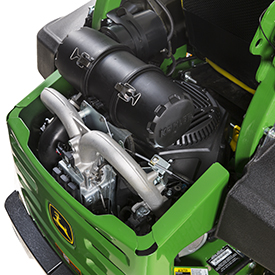 Z945M electronic fuel injection (EFI) engine
Z945M electronic fuel injection (EFI) engine
The Z945M EFI Mower is powered by an air-cooled, vertical shaft, electronically-fuel-injected engine:
- 27-hp (20.1-kW) gas engine
Engine features include:
- Electronic, closed-loop electronic fuel injection system with oxygen sensor
- Up to 25 percent better fuel economy than typical carbureted engines of similar power
- Cleaner emissions
- Easier starting
- No choke control or cable
- Better recovery under load
- Automatic optimization for altitude (air pressure), air temperature, engine temperature, and fuel blends up to E10
- Onboard diagnostics (blink codes) and plug-in diagnostics (Service ADVISOR™ system) for EFI system trouble codes
- Full-pressure lubrication with full-flow filter
- Reduces engine wear by ensuring proper lubrication, even when operating on hillsides or uneven terrain
- Oil filter helps keep oil clean for increased engine life
- V-twin big block design
- Vertical shaft
- Easy-access, dual-element air filter
- 20-amp alternator
- Electric fuel pump
- Complies with strict U.S. Environmental Protection Agency (EPA) emission standards without loss of horsepower or torque Aluminum block engines
- Effectively dissipate heat
- Lightweight and strong construction
- Extend engine life due to elimination of debilitating engine temperatures
- Air-cooled engine design
Air cleaner filters out dust that can damage an engine
 Engine air cleaner
Engine air cleaner
 Air cleaner cover removed
Air cleaner cover removed
ZTrak™ Z900 Mowers are equipped with a dual-element, canister-style air filter, easily accessible from the rear of the machine without tools.
- The filtration system pulls clean air from above the engine, in turn filtering out the dust that can damage an engine over time.
- Filters are extremely easy to change when required.
- Pre-cleaner provides more protection against contamination in dusty and dirty applications.
Mow all day on a single tank of fuel with efficient and easy-to-fill fuel tank
 Fuel tank and filler neck
Fuel tank and filler neck
 Fuel filler neck
Fuel filler neck
The ZTrak™ Z900 Mowers are equipped with one single-fill, top-draw fuel tank:
- 11.5-U.S. gal. (43.5-L) capacity enables operators to mow all day without refueling.
- The fuel gauge makes it quick and easy to see how much fuel is in the tank.
- Top draw provides added safety.
- A large fuel-filler neck is angled to make it easy for an operator to complete the fueling process.
Under normal conditions, load, and operation, fuel consumption for the Z900 ZTrak Mowers is 1.5 U.S. gph (5.7 L/hr) to 2.2 U.S. gph (8.3 L/hr), depending on the horsepower and conditions.
Durable hydrostatic drive train that delivers better cooling and provides easy access
 Heavy-duty ground drive
Heavy-duty ground drive
The hydrostatic drive features two 13-cc (0.8-cu in.) unitized hydraulic pumps combined with commercial-grade, heavy-duty wheel motors into a single unit.
One pump and one motor drive each wheel on the ZTrak™ E and M Series Mowers. This provides several benefits:
- Exceptional cooling in high-load conditions
- Easy-to-check level and refill hydraulic oil
- Opens up access under the seat
Three seat choices with ComfortGlide™ fore/aft suspension offer exceptional operator comfort
There are three seating options available for the M Series, all of which are factory installed:
- Deluxe comfort seat with armrests
- Deluxe comfort seat with armrests and isolation
- Fully adjustable suspension seat with armrests
ComfortGlide fore/aft suspension
 ComfortGlide fore/aft suspension control lever
ComfortGlide fore/aft suspension control lever
Each seat has the ComfortGlide fore/aft suspension system that gives superior ride comfort over uneven areas:
- Seat can travel up to 2 in. (50.8 mm) fore and aft to absorb bumps for a significant enhancement to ride comfort.
- Control lever provides the ability to easily lock out fore/aft suspension movement if desired.
- One lever has three functions:
- Slide seat forward and back 3 in. (10.2 cm) to allow the operator the ability to choose the leg room needed
- Activate ComfortGlide fore/aft seat suspension
- Lock out ComfortGlide fore/aft seat suspension
Deluxe comfort seat with armrests
 Deluxe comfort seat with armrests
Deluxe comfort seat with armrests
The deluxe comfort seat with armrests is standard on all E and M Series models:
- Rubber springs are provided to increase ride comfort.
- A convenient seat latch makes it easy to lift the seat.
- The seat is factory installed.
Deluxe comfort seat with armrests and isolation
 Deluxe comfort seat with armrests and isolation
Deluxe comfort seat with armrests and isolation
 Rubber isolation mount
Rubber isolation mount
The deluxe comfort seat with armrests and isolation is available on the E, M, and R Series:
- Rubber springs are provided to isolate the seat base and to increase ride comfort.
- A convenient seat latch makes it easy to lift the seat.
- Isolation mounting is a good feature to reduce vibration for operators who do not require the fully adjustable suspension seat option.
- Factory installed on Z900s ordered with the deluxe comfort seat with armrests and isolation option.
Fully adjustable suspension seat with armrests
 Fully adjustable, mechanical suspension-seat
Fully adjustable, mechanical suspension-seat
 Suspension seat control
Suspension seat control
A fully adjustable suspension seat with armrests option is available on the M and R Series:
- Adjustable back angle is provided for individual operator comfort.
- Adjustable lumbar support helps to suit the needs of the operator.
- A suspension seat control dial gives easy adjustment for operator weight and ride comfort.
- A convenient seat latch provides ease of lifting the seat.
- On Z900s ordered with the fully adjustable suspension seat with armrests option, it is factory installed.
Designed for operator comfort
 Operator station
Operator station
Two-lever hydrostatic control provides the following:
- The operator can select the ground speed and direction control simply by moving levers forward or reverse.
- Positive neutral lock position for levers provides added safety.
- Brake & Go operator-presence system returns levers to the neutral position when the brake pedal is actively engaged.
- Starting the machines is as easy as starting a car. It no longer matters if the control levers are extended out or pulled in, as long as the parking brake is engaged. Just turn the key and go.
- Wide-bend, large-diameter steering levers swing out easily for entry and exit from the operator platform.
Brake & Go starting system
 Parking brake pedal (Z900R Series)
Parking brake pedal (Z900R Series)
 Parking brake lever (Z900 E and M Series)
Parking brake lever (Z900 E and M Series)
The Brake & Go starting system is a John Deere exclusive. This feature makes the starting process on all ZTrak™ mowers easier, while also making it possible to remove two interlock switches from the machine.
The Brake & Go starting procedure helps a novice operator look and feel like a professional. To start the machine, the parking brake must be engaged. It does not matter whether the power take-off (PTO) switch is on or off, nor does it matter if the control levers are pulled in or in the out position.
As long as the parking brake is engaged, the machine will start. When the parking brake is applied, the control levers cannot be moved to the forward or reverse positions.
Adjustable levers
 Adjustable levers
Adjustable levers
The motion control levers have two height positions and can also be adjusted forward or rearward within the slotted holes. The levers should be adjusted so the operator can achieve a full range of control operation comfortably.
Tracking adjustment
 Tracking adjustment
Tracking adjustment
The easy-to-turn (from-the-seat) tracking adjustment allows operators to keep their mowers straight and produce professional striping results.
Onboard storage and cup holder
 Onboard storage
Onboard storage
 Cup holder
Cup holder
Several storage areas are provided on the ZTrak machines. A convenient cup holder is also available.
Right-hand control panel
 Right-hand control panel
Right-hand control panel
 Right-hand control panel
Right-hand control panel
The controls are grouped together on the right console, providing one central location for key switch, throttle, PTO engagement, height-of-cut, diagnostics, and hour meter.
- Rocker-type PTO switch
- Height-of-cut knob with transport lock
- Key switch
- Hourmeter
- Throttle
- Separate choke control
- Easy choke operation yields less fouling of plugs
- No choke required for the electronic fuel injection (EFI) models
Easy-to-operate height-of-cut adjustment enables on-the-go changes
 Mower deck height adjustment knob
Mower deck height adjustment knob
An easy-to-use cutting-height lift system allows the operator to adjust the mower deck height with no tools and minimal effort. The easy-to-grip knob allows operators to dial in the desired height of cut (HOC).
Cutting height can be adjusted from approximately 1 in. to 5.5 in. (2.5 cm to 14 cm). Each increment on the knob adjusts the HOC approximately 0.25 in. (0.64 cm). The deck can also be raised and locked in a transport position to provide maximum ground clearance when moving the machine from one area to another.
The transport lock function allows the deck to be returned to the previous HOC after being in the transport position:
- Use the foot-lift pedal to lift the deck and engage the transport lock.
- Rotate the knob to adjust from 1 in. to 5.5 in. (2.5 cm to 14 cm) in 0.25-in. (0.64 cm) increments.
This design increases productivity by allowing operators to change the cutting height without having to leave the seat.
Mower is easy to service with many accessible components
 Z955R EFI left front view
Z955R EFI left front view
The design of the Z900 Series makes many service components reachable and easily accessible from the ground.
- Large, open engine compartment at the rear of the machine provides convenient servicing and ensures the engine heat is directed away from the operator.
 Flip-up foot panel
Flip-up foot panel
 Flip-up seat
Flip-up seat
Onboard maintenance chart
 Maintenance chart
Maintenance chart
All ZTrak™ Mowers come with an onboard maintenance chart that is conveniently located inside the right-hand console. The service interval chart gives necessary service intervals.
Diagnostics
 Hour meter (M Series pictured)
Hour meter (M Series pictured)
 Diagnostic chart
Diagnostic chart
The hour meter shows the number of hours the machine is run when the key switch is in the on position. It only counts the hours the engine is actually running. Machine diagnostics are the first step of a monitoring system to help operators quickly diagnose common downtime issues. A trouble code light is included on the hour meter.
Use of the hour meter and service interval chart helps determine when the machine will need service.
Rollover protective structure (ROPS) enhances operator safety
 ROPS up
ROPS up
 ROPS mid position
ROPS mid position
 ROPS down position
ROPS down position
The ZTrak™ Z900E, M, and R Series Mowers are equipped with a standard two-post folding ROPS and seat belt. The folding ROPS enhances operator safety and provides ample clearance when storing the mower in garages or sheds:
- ISO21299 certification
- Foldable
The ROPS system can be repositioned without the use of tools. Under normal operation, the ROPS should be in the up position. If operating in low clearance areas, they can be folded and secured out of the way. The ROPS can also be pinned halfway down to accommodate machines equipped with a material collection system.
Three-year, bumper-to-bumper warranty
 Z955M ZTrak™ Mower
Z955M ZTrak™ Mower
 Z955R ZTrak Mower
Z955R ZTrak Mower
E and M Series 3-year, 1200-hour bumper-to-bumper warranty
An exclusive 2-year, unlimited hour/3-year, 1200-hour (whichever comes first) bumper-to-bumper warranty is standard for all John Deere E and M Series Mowers. The warranty is best in its class and places John Deere at the forefront of commercial mowing. It is also hassle free, with one company handling all of the paperwork.
NOTE: 36 months or 1200 hours, whichever comes first. For the first 24 months, there is no hour limitation.
R Series 3-year, 1500-hour bumper-to-bumper warranty
An exclusive 2-year, unlimited hour/3-year, 1500-hour (whichever comes first) bumper-to-bumper warranty is standard on all John Deere R Series mowers. The warranty is best in the industry and puts John Deere at the forefront of commercial mowing. It is also hassle free, with one company handling all of the paperwork.
NOTE: 36 months or 1500 hours, whichever comes first. For the first 24 months, there is no hour limitation.
Mower decks are safety certified
 Z950M ZTrak Mower
Z950M ZTrak Mower
Mowers decks are evaluated by the manufacturer (John Deere Turf Care) and conform to American National Standards Institute (ANSI) B71.4 2004 safety certification specifications for commercial turf care equipment.
Durable 7-Iron™ PRO decks pressed from a single piece of steel
 72-in. (183-cm) 7-Iron PRO deck shown
72-in. (183-cm) 7-Iron PRO deck shown
The ZTrak™ M and R Series Mowers are equipped with either a side-discharge or Mulch On Demand™ 7-Iron PRO deck.
7-Iron PRO mower decks have demonstrated quality, performance, and durability. They deliver a high quality cut in diverse conditions.
Key features of the 7-Iron PRO mower deck:
- Deck is stamped from 7-gauge, 0.179-in. (4.6-mm) steel to minimize the number of welds and provide a smooth underside with fewer sharp corners for reduced material buildup.
- Significantly fewer welds on the deck shell to wear or break - it is stamped from a single sheet of steel rather than multiple fabrications. An anti-skid step on the deck provides easy machine mounting.
- Higher blade tip speed than many competitors - 18,500 fpm (5,639 m/min) for more blade cuts per inch mowed.
- A deep-deck design of 5.5 in. (14 cm) delivers excellent airflow so material can be processed quickly and efficiently.
- The wider and higher discharge opening provides even clipping dispersal for an excellent finished appearance in all conditions.
 Mower rectangular leading-edge reinforcement
Mower rectangular leading-edge reinforcement
 Dual-captured anti-scalp wheel
Dual-captured anti-scalp wheel
Key features of the 7-Iron PRO mower deck:
- Deck has rectangular leading deck edge reinforcement and the rounded corners of the stamped deck help distribute impact stress to reduce the potential of damage when the mower contacts trees, rocks, curbs, and other fixed obstacles.
- Dual-captured front and rear anti-scalp wheels provide deck flotation over even the toughest terrain.
- Three 1-in. (2.5-cm), cold-forged spindles are heat-treated for strength without bulk and are supported by ball bearings, providing reliability and performance; spindle housings are ribbed cast aluminum providing both excellent strength and heat dissipation.
- The front edge is raised above the blade plane to allow even cutting of tall grass and is reinforced with a square bar for durability. The front baffle has been redesigned to better manage airflow and control clippings.
- Three spindle grease fittings are accessible from the top.
- Blade overlap is 1.6 in. (40.6 mm), nearly 0.79 in. (20 mm) greater than previous decks, to reduce striping between blades.
- Quick-change, cutting-height adjustment.
7-Iron PRO mower deck
| M Series | R Series |
| Z920M - 48 in. (122 cm), 54 in. (137 cm), 60 in. (152 cm) | Z930R - 54 in. (137 cm), 60 in. (152 cm) |
| Z930M - 54 in. (137 cm), 60 in. (152 cm) | Z950R - 60 in. (152 cm), 72 in. (183 cm) |
| Z945M EFI - 60 in. (152 cm) | Z955R EFI - 60 in. (152 cm) |
| Z950M - 60 in. (152 cm), 72 in. (183 cm) | Z970R - 60 in. (152 cm), 72 in. (183 cm) |
| Z955M EFI - 60 in. (152 cm), 72 in. (183 cm) | |
| Z960M - 60 in. (152 cm), 72 in. (183 cm) |
 Mower deck step shown on 72-in. (183-cm) mower
Mower deck step shown on 72-in. (183-cm) mower
The deck step safely aids the operator's entrance and egress from machine.
Available Mulch On Demand™ deck
 Mulch On Demand mower deck
Mulch On Demand mower deck
 Mower deck with chute closed
Mower deck with chute closed
The Mulch On Demand mower deck delivers unprecedented levels of productivity and versatility to commercial mower operation. With the ability to switch between side discharge and mulching operation with the flip of a lever as the operator mows, keeping most clippings out of landscaping features and where they are wanted is extremely easy.
 Mulch On Demand open
Mulch On Demand open
![Mulch On Demand closed (latch standard on material collection system [MCS] equipped models only)](https://salesmanual.deere.com/sales/salesmanual/images/NA/commercial_mowers/features_attachment/ztraks_com/480295_mod_deck_oval_275x175.jpg) Mulch On Demand closed (latch standard on material collection system [MCS] equipped models only)
Mulch On Demand closed (latch standard on material collection system [MCS] equipped models only)
 Lever position open (latch standard on MCS-equipped models only)
Lever position open (latch standard on MCS-equipped models only)
 Lever position closed
Lever position closed
Key features of the 7-Iron™ PRO Mulch On Demand mower deck:
- Deck can be converted from a wide-open side discharge mode to a fully chambered mulching mode with a single move of a lever.
- NOTE: Mulch On Demand decks are a balance between a side discharge deck and a side discharge deck with a mulching kit.
- Deck is stamped from 7-gauge, 0.179-in. (4.6-mm) steel to minimize the number of welds and provide a smooth underside, with fewer sharp corners, for reduced material buildup.
- Significantly fewer welds on the deck shell to wear or break- it is stamped from a single sheet of steel rather than multiple fabrications. Anti-skid step on the deck provides for easy machine mounting.
- Mulch On Demand decks are superior to aftermarket chute blockers due to the movable baffles.
- Higher blade tip speed than many competitors - 18,500 fpm (5,639 m/min) for more blade cuts per inch mowed.
- Rounded corners of the stamped deck help distribute impact stress to reduce the potential of damage when the mower contacts trees, rocks, curbs, and other fixed obstacles.
- Deep-deck design of 5.5 in. (14 cm) delivers excellent airflow so material can be processed quickly and efficiently.
- Wider and higher discharge opening provides even clipping dispersal for an excellent finished appearance in all conditions.
- Three 1-in. (2.5 cm) cold-forged spindles are heat-treated for strength without bulk and are supported by ball bearings, providing reliability and performance; spindle housings are ribbed cast aluminum providing both excellent strength and heat dissipation.
- The front edge is raised above the blade plane to allow even cutting of tall grass and reinforced with a square bar for durability. The front baffle has been redesigned to better manage airflow and control clippings.
- Dual-captured anti-scalp wheels provide deck flotation over even the toughest terrain.
- Three greasable spindle zerks accessible from the top.
- Blade overlap is 1.6 in. (40 mm), nearly 0.79 in. (20 mm) greater than previous decks, to reduce striping between blades.
- Quick-change, cutting-height adjustment.
7-Iron PRO Mulch On Demand mower deck
| M Series | R Series |
| Z920M - 48-in. (122-cm) Mulch On Demand | Z930R - 54-in. (137-cm) Mulch On Demand |
| Z930M - 54-in. (137-cm) Mulch On Demand Z930M - 60-in. (152-cm) Mulch On Demand |
Z950R - 60-in. (152-cm) Mulch On Demand |
| Z945M EFI - 60-in. (152-cm) Mulch On Demand | Z970R - 60-in. (152-cm) Mulch On Demand |
| Z950M - 60-in. (152-cm) Mulch On Demand | |
| Z955M EFI - 60-in. (152-cm) Mulch On Demand | |
| Z960M - 60-in. (152-cm) Mulch On Demand |
Spindle assembly provides greater performance and reliability
 Spindle assembly
Spindle assembly
On every John Deere ZTrak™ mower deck, there are three 1-in. (2.5-cm) spindles that are cold-forged and heat-treated for strength without bulk. The spindles are supported by precision ball bearings, providing great performance and reliability.
The spindle housing is made of aircraft-grade, ribbed cast aluminum. This unique casting design embosses reinforcing gussets in the housing, which adds both strength and cooling surface area that stands up to commercial applications.
These spindles can be greased from the top and require no disassembly to reach. Grease channels provide lubrication to both bearings.
Features
Heavy-duty frame provides strength and durability
 Z955R EFI model shown with optional X® Tweel® Turf airless radial tire technology
Z955R EFI model shown with optional X® Tweel® Turf airless radial tire technology

The durability features of the frame are as follows:
-
Heavy-duty, thick-gauge, steel channel mainframe for strength and durability
-
Cast I-beam caster arms to handle the beating and pounding professional mowers receive
-
Wide-open access for maintenance and cleaning
Two-piece rear bumper provides protection
 Illustration of ZTrak™ mower rear bumper
Illustration of ZTrak™ mower rear bumper
A steel rear bumper provides protection for the machine. The bumper is made of two pieces, making it easy to remove and install when using a material collection system (MCS).
A rear hitch can be added to the steel bumper for towing purposes. ZTrak E, M, and R Series Mowers can tow up to 400 lb (181.4 kg).
Michelin, X, and Tweel are trademarks of Michelin North America, Inc.
Michelin® X® Tweel® Turf airless radial tire technology for ZTrak™ Mowers eliminates downtime and reduces cost of operation
 Flat-free rear tire shown on ZTrak™ Mower
Flat-free rear tire shown on ZTrak™ Mower
John Deere provides the commercial mower industry with the Michelin X Tweel Turf technology for Commercial ZTrak Mowers:
- 24x12N12 as an ordering option code for ZTrak Gas Mowers with 54 in., 60 in., and 72 in. (137-cm, 152-cm, and 183-cm) Mower Decks
- 24x12N12 is also available as base code equipment for ZTrak Gas Mowers with 54 in., 60 in., and 72 in. (137-cm, 152-cm, and 183-cm) Mower Decks (ordering information available at Configurator on the Tweel model page)
- 24x12N12 as an ordering option code for ZTrak Z994R Diesel with 54 in., 60 in., and 72 in. (137-cm, 152-cm, and 183 cm) Mower Decks
- 26x12N12 as an ordering option code for Z997R Diesel with 60 in. and 72 in. (152-cm and 183-cm) Mower Decks
Michelin is a world leader in tire manufacturing and technology. This airless radial tire solution is an industry first for John Deere, which provides an additional advantage to John Deere customers.
Advantages of the Michelin X Tweel Turf include:
- Mowing performance is improved.
- Rutting is reduced because the Michelin X Tweel Turf has more support across the surface for improved flotation and better ground contact.
- Unique energy transfer within the poly-resin spokes reduces the bounce associated with pneumatic tires.
- Excellent curb climbing is possible due to the Michelin X Tweel Turf construction and flexibility.
- More consistent cut quality is achieved because inconsistent tire pressure is eliminated.
- Uptime is improved.
- The exclusive technology eliminates downtime and associated cost due to flat or damaged tires.
- Punctures and sidewall damage no longer result in downtime.
- Cost of operation is reduced.
- Cost of repairs and maintenance is reduced. One single unit replaces the current tire, wheel, and valve assembly. There is no need for complex tire-mounting equipment.
- No need to spend time checking and optimizing tire pressure.
- The need to purchase and stock plug kits and spare tires is eliminated, particularly for professional landscape contractors and government agencies who normally stock them.
- The tire tread will last up to three times longer than current pneumatic tires because automotive-grade rubber is used for the tread.
 Michelin X Tweel Turf
Michelin X Tweel Turf
 Michelin X Tweel Turf
Michelin X Tweel Turf
Heavy-duty construction provides the ultimate in performance and reliable operation:
- High-strength poly-resin spokes carry the load.
- Four-hole, heavy-duty steel hub for durability.
- Deep, open-tread design provides excellent cleaning and traction.
- Zero degree, high-tensile proprietary carcass provides great lateral stiffness while resisting damage from impact and penetration.
NOTE: In some cases, different size Tweel tires are required depending on the mower deck size.
Tires deliver exceptional traction and maneuverability
 Drive tire
Drive tire
 Front caster tire
Front caster tire
The ZTrak M Series Mowers with 48-in. (122-cm) mower decks come with 24x9.5-12 4 PR drive tires. M Series Mowers with 54-in. (137-cm), 60-in. (152-cm), and 72-in. (183-cm) decks come with 24x12-12 4 PR drive tires. All M Series Mowers are equipped with 13x6.5-6 front flat-free semi-pneumatic caster tires for the following:
- Excellent traction, flotation, and curb climbing
- Low center of gravity to increase hillside mowing capability
- Caster wheels and caster wheel towers with sealed bearings for long life and easy steering
- Offset front caster wheels to help improve the inside corner-trim performance and also reduce between-blade striping
Michelin, X, and Tweel are trademarks of Michelin North America, Inc.
Field-installed propane conversion kits for Commercial Walk-Behind Mowers, QuikTrak™ Mowers, and Commercial ZTrak™ Mowers
 Propane conversion kit on a Walk-Behind Mower
Propane conversion kit on a Walk-Behind Mower
 Propane conversion kit on a ZTrak Mower
Propane conversion kit on a ZTrak Mower
John Deere provides application-specific Environmental Protection Agency (EPA) approved field-installed propane conversion kits for specific John Deere Commercial Walk-Behind Mowers, QuikTrak Mowers, and ZTrak Mowers. The conversion kits include all components required to convert the engines to operate on propane fuel. Single-tank or dual-tank brackets (depending on the vehicle) are provided for securely holding the propane tank(s) to the vehicle.
Propane tanks are not included.
An optional altitude kit is required when operating at altitudes above 2000 ft (610 m). The operator’s manual with the propane conversion kit provides further details. Parts must be ordered separately through John Deere Parts.
Propane facts:
- Propane is flammable and commonly used as a fuel.
- The molecular formula of propane is C3H8, and it is in the family of liquefied petroleum gases (LP gases). The other LP gases include butane, propylene, butadiene, butylene, isobutylene, and mixtures thereof.
- Propane is commonly available and has proven to be a dependable, safe, economical, and clean-burning fuel. It can be used as household fuel, industrial fuel, and fuel for internal combustion engines. Propane has been used as a fuel since 1910.
- At atmospheric pressure, propane boils at -44°F (-42.2°C), meaning it typically exists as a vapor. However, when contained under pressure, such as in a propane cylinder, it can exist as a liquid.
- Propane is naturally odorless, but includes an additive odorant, usually mercaptan, which gives it a distinct odor.
- Vapor propane is heavier than air, meaning it will settle in low areas such as along the ground or in drains.
Advantages of John Deere propane conversion kits include:
- Reduced fuel costs, up to 30 percent depending on fuel prices
- Lower emissions
- Reduced fuel-system maintenance
- Maintains John Deere warranty
- EPA and CARB certified
- May qualify for national and state rebate and incentive programs. Please visit www.propane.com/commercial-landscape/programs-and-incentives/ for further information.
Propane tank mounting bracket options:
 Single propane tank shown on QuikTrak Mower
Single propane tank shown on QuikTrak Mower
 Dual propane tanks shown on ZTrak Mower
Dual propane tanks shown on ZTrak Mower
Optional tank configurations and sizes are available to provide operators the ability to tailor for run time:
- Commercial Walk-Behind Mowers have only a single-tank mounting option.
- The single-tank bracket is designed for one 20-lb (9.1-kg) or 33-lb (15-kg) Worthington tank.
- Tank is not included.
- The single-tank bracket is designed for one 20-lb (9.1-kg) or 33-lb (15-kg) Worthington tank.
- QuikTrak Mowers have single-tank and dual-tank mounting options.
- The single-tank, right-side bracket is designed for one 33-lb (15-kg) Worthington tank.
- Tank is not included.
- The dual-tank brackets are designed for two 20-lb (9.1-kg) Worthington tanks.
- Tanks are not included.
- The single-tank, right-side bracket is designed for one 33-lb (15-kg) Worthington tank.
- ZTrak Mowers have single-tank and dual-tank mounting options.
- The single-tank, left-side bracket is designed for one 33-lb (15-kg) or 43-lb (19.5-kg) Worthington tank.
- Tank is not included.
- The dual-tank brackets are designed for two 33-lb (15-kg) Worthington tanks.
- Tanks are not included.
- ZTrak Mowers with dual-tank configurations are not compatible with any material collection systems.
NOTE: Reference the Propane and Attachment Compatibility Chart to determine tank configurations that are compatible.
Estimated run-time comparison
| Engine displacement | FS603cc | FS726cc | FX726cc | FX852cc |
| Average consumption (lb [kg]/hr) | 3.9 (1.8) | 4.2 (1.9) | 4.2 (1.9) | 5.8 (2.6) |
| Run time (hours) with 20-lb (9.1-kg) tank | 5.1 | 4.8 | 4.8 | 3.4 |
| Run time (hours) with 33.5-lb (15.2-kg) tank | Not available | 8.0 | 8.0 | 5.8 |
| Run time (hours) with 43.5-lb (19.7-kg) tank | Not available | 10.4 | 10.4 | 7.5 |
Field-installed propane conversion kit compatibility:
NOTE: Conversion to propane is not intended for units with engines having more than 250 hours of use.
Commercial Walk-Behind Mowers (model year 2018 and prior)
| WG Series | WH Series | WHP Series | |||||||||
| Model | WG32A | WG36A | WG48A | WH36A | WH48A | WH52A | WH61A | WHP36A | WHP48A | WHP52A | WHP61A |
| Engine model | FS481V | FS481V | FS481V | FS481V | FS600V | FS600V | FS691V | FS481V | FS600V | FS600V | FS691V |
| Engine displacement | 603 cc | 603 cc | 603 cc | 603 cc | 603 cc | 603 cc | 726 cc | 603 cc | 603 cc | 603 cc | 726 cc |
| Propane kit model number | Not available | Not available | Not available | FS603cc | FS603cc | FS603cc | FS726cc | FS603cc | FS603cc | FS603cc | FS726cc |
QuikTrak Mowers
| E Series | M Series | R Series | |||||||
| Model | 652E | 636M | 648M | 652M | 648R | 652R | 652R EFI | 661R | 661R EFI |
| Engine model | FX691V | FS600V | FX691V | FX691V | FX691V | FX730V | ECV740 EFI | FX730V | ECV740 EFI |
| Engine displacement | 726 cc | 603 cc | 726 cc | 726 cc | 726 cc | 726 cc | 747 cc | 726 cc | 747 cc |
| Propane kit model number | FX726cc | Not available | Not available | Not available | FX726cc | FX726cc | Not available | FX726cc | Not available |
Commercial ZTrak Mowers
| E Series | M Series | R Series | |||||||||
| Model | Z915E | Z920M | Z930M | Z945M EFI | Z950M | Z955M EFI | Z960M | Z930R | Z950R | Z955R EFI | Z970R |
| Engine model | CV742 | FX730V | FX801V | ECV850 EFI | FX850V | ECV860J EFI | FX921V | FX801V | FX850V | ECV860J EFI | FX1000V |
| Engine displacement | 747 cc | 726 cc | 852 cc | 824 cc | 852 cc | 824 cc | 999 cc | 852 cc | 852 cc | 824 cc | 999 cc |
| Propane kit model number | Not available | FX726cc* | FX852cc* | Not available | FX852cc* | Not available | Not available | FX852cc* | FX852cc* | Not available | Not available |
Worthington tanks are manufactured by Worthington Industries, Inc.
Durable hydrostatic drive train that delivers better cooling and provides easy access
 Heavy-duty ground drive
Heavy-duty ground drive
The hydrostatic drive features two 13-cc (0.8-cu in.) unitized hydraulic pumps combined with commercial-grade, heavy-duty wheel motors into a single unit.
One pump and one motor drive each wheel on the ZTrak™ E and M Series Mowers. This provides several benefits:
- Exceptional cooling in high-load conditions
- Easy-to-check level and refill hydraulic oil
- Opens up access under the seat
Three seat choices with ComfortGlide™ fore/aft suspension offer exceptional operator comfort
There are three seating options available for the M Series, all of which are factory installed:
- Deluxe comfort seat with armrests
- Deluxe comfort seat with armrests and isolation
- Fully adjustable suspension seat with armrests
ComfortGlide fore/aft suspension
 ComfortGlide fore/aft suspension control lever
ComfortGlide fore/aft suspension control lever
Each seat has the ComfortGlide fore/aft suspension system that gives superior ride comfort over uneven areas:
- Seat can travel up to 2 in. (50.8 mm) fore and aft to absorb bumps for a significant enhancement to ride comfort.
- Control lever provides the ability to easily lock out fore/aft suspension movement if desired.
- One lever has three functions:
- Slide seat forward and back 3 in. (10.2 cm) to allow the operator the ability to choose the leg room needed
- Activate ComfortGlide fore/aft seat suspension
- Lock out ComfortGlide fore/aft seat suspension
Deluxe comfort seat with armrests
 Deluxe comfort seat with armrests
Deluxe comfort seat with armrests
The deluxe comfort seat with armrests is standard on all E and M Series models:
- Rubber springs are provided to increase ride comfort.
- A convenient seat latch makes it easy to lift the seat.
- The seat is factory installed.
Deluxe comfort seat with armrests and isolation
 Deluxe comfort seat with armrests and isolation
Deluxe comfort seat with armrests and isolation
 Rubber isolation mount
Rubber isolation mount
The deluxe comfort seat with armrests and isolation is available on the E, M, and R Series:
- Rubber springs are provided to isolate the seat base and to increase ride comfort.
- A convenient seat latch makes it easy to lift the seat.
- Isolation mounting is a good feature to reduce vibration for operators who do not require the fully adjustable suspension seat option.
- Factory installed on Z900s ordered with the deluxe comfort seat with armrests and isolation option.
Fully adjustable suspension seat with armrests
 Fully adjustable, mechanical suspension-seat
Fully adjustable, mechanical suspension-seat
 Suspension seat control
Suspension seat control
A fully adjustable suspension seat with armrests option is available on the M and R Series:
- Adjustable back angle is provided for individual operator comfort.
- Adjustable lumbar support helps to suit the needs of the operator.
- A suspension seat control dial gives easy adjustment for operator weight and ride comfort.
- A convenient seat latch provides ease of lifting the seat.
- On Z900s ordered with the fully adjustable suspension seat with armrests option, it is factory installed.
Designed for operator comfort
 Operator station
Operator station
Two-lever hydrostatic control provides the following:
- The operator can select the ground speed and direction control simply by moving levers forward or reverse.
- Positive neutral lock position for levers provides added safety.
- Brake & Go operator-presence system returns levers to the neutral position when the brake pedal is actively engaged.
- Starting the machines is as easy as starting a car. It no longer matters if the control levers are extended out or pulled in, as long as the parking brake is engaged. Just turn the key and go.
- Wide-bend, large-diameter steering levers swing out easily for entry and exit from the operator platform.
Onboard storage and cup holder
 Onboard storage
Onboard storage
 Cup holder
Cup holder
Several storage areas are provided on the ZTrak machines. A convenient cup holder is also available.
Brake & Go starting system
 Parking brake pedal (Z900R Series)
Parking brake pedal (Z900R Series)
 Parking brake lever (Z900 E and M Series)
Parking brake lever (Z900 E and M Series)
The Brake & Go starting system is a John Deere exclusive. This feature makes the starting process on all ZTrak™ mowers easier, while also making it possible to remove two interlock switches from the machine.
The Brake & Go starting procedure helps a novice operator look and feel like a professional. To start the machine, the parking brake must be engaged. It does not matter whether the power take-off (PTO) switch is on or off, nor does it matter if the control levers are pulled in or in the out position.
As long as the parking brake is engaged, the machine will start. When the parking brake is applied, the control levers cannot be moved to the forward or reverse positions.
Adjustable levers
 Adjustable levers
Adjustable levers
The motion control levers have two height positions and can also be adjusted forward or rearward within the slotted holes. The levers should be adjusted so the operator can achieve a full range of control operation comfortably.
Tracking adjustment
 Tracking adjustment
Tracking adjustment
The easy-to-turn (from-the-seat) tracking adjustment allows operators to keep their mowers straight and produce professional striping results.
Right-hand control panel
 Right-hand control panel
Right-hand control panel
 Right-hand control panel
Right-hand control panel
The controls are grouped together on the right console, providing one central location for key switch, throttle, PTO engagement, height-of-cut, diagnostics, and hour meter.
- Rocker-type PTO switch
- Height-of-cut knob with transport lock
- Key switch
- Hourmeter
- Throttle
- Separate choke control
- Easy choke operation yields less fouling of plugs
- No choke required for the electronic fuel injection (EFI) models
Easy-to-operate height-of-cut adjustment enables on-the-go changes
 Mower deck height adjustment knob
Mower deck height adjustment knob
An easy-to-use cutting-height lift system allows the operator to adjust the mower deck height with no tools and minimal effort. The easy-to-grip knob allows operators to dial in the desired height of cut (HOC).
Cutting height can be adjusted from approximately 1 in. to 5.5 in. (2.5 cm to 14 cm). Each increment on the knob adjusts the HOC approximately 0.25 in. (0.64 cm). The deck can also be raised and locked in a transport position to provide maximum ground clearance when moving the machine from one area to another.
The transport lock function allows the deck to be returned to the previous HOC after being in the transport position:
- Use the foot-lift pedal to lift the deck and engage the transport lock.
- Rotate the knob to adjust from 1 in. to 5.5 in. (2.5 cm to 14 cm) in 0.25-in. (0.64 cm) increments.
This design increases productivity by allowing operators to change the cutting height without having to leave the seat.
Mower is easy to service with many accessible components
 Z955R EFI left front view
Z955R EFI left front view
The design of the Z900 Series makes many service components reachable and easily accessible from the ground.
- Large, open engine compartment at the rear of the machine provides convenient servicing and ensures the engine heat is directed away from the operator.
 Flip-up foot panel
Flip-up foot panel
 Flip-up seat
Flip-up seat
Onboard maintenance chart
 Maintenance chart
Maintenance chart
All ZTrak™ Mowers come with an onboard maintenance chart that is conveniently located inside the right-hand console. The service interval chart gives necessary service intervals.
Diagnostics
 Hour meter (M Series pictured)
Hour meter (M Series pictured)
 Diagnostic chart
Diagnostic chart
The hour meter shows the number of hours the machine is run when the key switch is in the on position. It only counts the hours the engine is actually running. Machine diagnostics are the first step of a monitoring system to help operators quickly diagnose common downtime issues. A trouble code light is included on the hour meter.
Use of the hour meter and service interval chart helps determine when the machine will need service.
Rollover protective structure (ROPS) enhances operator safety
 ROPS up
ROPS up
 ROPS mid position
ROPS mid position
 ROPS down position
ROPS down position
The ZTrak™ Z900E, M, and R Series Mowers are equipped with a standard two-post folding ROPS and seat belt. The folding ROPS enhances operator safety and provides ample clearance when storing the mower in garages or sheds:
- ISO21299 certification
- Foldable
The ROPS system can be repositioned without the use of tools. Under normal operation, the ROPS should be in the up position. If operating in low clearance areas, they can be folded and secured out of the way. The ROPS can also be pinned halfway down to accommodate machines equipped with a material collection system.
Three-year, bumper-to-bumper warranty
 Z955M ZTrak™ Mower
Z955M ZTrak™ Mower
 Z955R ZTrak Mower
Z955R ZTrak Mower
E and M Series 3-year, 1200-hour bumper-to-bumper warranty
An exclusive 2-year, unlimited hour/3-year, 1200-hour (whichever comes first) bumper-to-bumper warranty is standard for all John Deere E and M Series Mowers. The warranty is best in its class and places John Deere at the forefront of commercial mowing. It is also hassle free, with one company handling all of the paperwork.
NOTE: 36 months or 1200 hours, whichever comes first. For the first 24 months, there is no hour limitation.
R Series 3-year, 1500-hour bumper-to-bumper warranty
An exclusive 2-year, unlimited hour/3-year, 1500-hour (whichever comes first) bumper-to-bumper warranty is standard on all John Deere R Series mowers. The warranty is best in the industry and puts John Deere at the forefront of commercial mowing. It is also hassle free, with one company handling all of the paperwork.
NOTE: 36 months or 1500 hours, whichever comes first. For the first 24 months, there is no hour limitation.
Mower decks are safety certified
 Z950M ZTrak Mower
Z950M ZTrak Mower
Mowers decks are evaluated by the manufacturer (John Deere Turf Care) and conform to American National Standards Institute (ANSI) B71.4 2004 safety certification specifications for commercial turf care equipment.
Durable 7-Iron™ PRO decks pressed from a single piece of steel
 72-in. (183-cm) 7-Iron PRO deck shown
72-in. (183-cm) 7-Iron PRO deck shown
The ZTrak™ M and R Series Mowers are equipped with either a side-discharge or Mulch On Demand™ 7-Iron PRO deck.
7-Iron PRO mower decks have demonstrated quality, performance, and durability. They deliver a high quality cut in diverse conditions.
Key features of the 7-Iron PRO mower deck:
- Deck is stamped from 7-gauge, 0.179-in. (4.6-mm) steel to minimize the number of welds and provide a smooth underside with fewer sharp corners for reduced material buildup.
- Significantly fewer welds on the deck shell to wear or break - it is stamped from a single sheet of steel rather than multiple fabrications. An anti-skid step on the deck provides easy machine mounting.
- Higher blade tip speed than many competitors - 18,500 fpm (5,639 m/min) for more blade cuts per inch mowed.
- A deep-deck design of 5.5 in. (14 cm) delivers excellent airflow so material can be processed quickly and efficiently.
- The wider and higher discharge opening provides even clipping dispersal for an excellent finished appearance in all conditions.
 Mower rectangular leading-edge reinforcement
Mower rectangular leading-edge reinforcement
 Dual-captured anti-scalp wheel
Dual-captured anti-scalp wheel
Key features of the 7-Iron PRO mower deck:
- Deck has rectangular leading deck edge reinforcement and the rounded corners of the stamped deck help distribute impact stress to reduce the potential of damage when the mower contacts trees, rocks, curbs, and other fixed obstacles.
- Dual-captured front and rear anti-scalp wheels provide deck flotation over even the toughest terrain.
- Three 1-in. (2.5-cm), cold-forged spindles are heat-treated for strength without bulk and are supported by ball bearings, providing reliability and performance; spindle housings are ribbed cast aluminum providing both excellent strength and heat dissipation.
- The front edge is raised above the blade plane to allow even cutting of tall grass and is reinforced with a square bar for durability. The front baffle has been redesigned to better manage airflow and control clippings.
- Three spindle grease fittings are accessible from the top.
- Blade overlap is 1.6 in. (40.6 mm), nearly 0.79 in. (20 mm) greater than previous decks, to reduce striping between blades.
- Quick-change, cutting-height adjustment.
7-Iron PRO mower deck
| M Series | R Series |
| Z920M - 48 in. (122 cm), 54 in. (137 cm), 60 in. (152 cm) | Z930R - 54 in. (137 cm), 60 in. (152 cm) |
| Z930M - 54 in. (137 cm), 60 in. (152 cm) | Z950R - 60 in. (152 cm), 72 in. (183 cm) |
| Z945M EFI - 60 in. (152 cm) | Z955R EFI - 60 in. (152 cm) |
| Z950M - 60 in. (152 cm), 72 in. (183 cm) | Z970R - 60 in. (152 cm), 72 in. (183 cm) |
| Z955M EFI - 60 in. (152 cm), 72 in. (183 cm) | |
| Z960M - 60 in. (152 cm), 72 in. (183 cm) |
 Mower deck step shown on 72-in. (183-cm) mower
Mower deck step shown on 72-in. (183-cm) mower
The deck step safely aids the operator's entrance and egress from machine.
Available Mulch On Demand™ deck
 Mulch On Demand mower deck
Mulch On Demand mower deck
 Mower deck with chute closed
Mower deck with chute closed
The Mulch On Demand mower deck delivers unprecedented levels of productivity and versatility to commercial mower operation. With the ability to switch between side discharge and mulching operation with the flip of a lever as the operator mows, keeping most clippings out of landscaping features and where they are wanted is extremely easy.
 Mulch On Demand open
Mulch On Demand open
![Mulch On Demand closed (latch standard on material collection system [MCS] equipped models only)](https://salesmanual.deere.com/sales/salesmanual/images/NA/commercial_mowers/features_attachment/ztraks_com/480295_mod_deck_oval_275x175.jpg) Mulch On Demand closed (latch standard on material collection system [MCS] equipped models only)
Mulch On Demand closed (latch standard on material collection system [MCS] equipped models only)
 Lever position open (latch standard on MCS-equipped models only)
Lever position open (latch standard on MCS-equipped models only)
 Lever position closed
Lever position closed
Key features of the 7-Iron™ PRO Mulch On Demand mower deck:
- Deck can be converted from a wide-open side discharge mode to a fully chambered mulching mode with a single move of a lever.
- NOTE: Mulch On Demand decks are a balance between a side discharge deck and a side discharge deck with a mulching kit.
- Deck is stamped from 7-gauge, 0.179-in. (4.6-mm) steel to minimize the number of welds and provide a smooth underside, with fewer sharp corners, for reduced material buildup.
- Significantly fewer welds on the deck shell to wear or break- it is stamped from a single sheet of steel rather than multiple fabrications. Anti-skid step on the deck provides for easy machine mounting.
- Mulch On Demand decks are superior to aftermarket chute blockers due to the movable baffles.
- Higher blade tip speed than many competitors - 18,500 fpm (5,639 m/min) for more blade cuts per inch mowed.
- Rounded corners of the stamped deck help distribute impact stress to reduce the potential of damage when the mower contacts trees, rocks, curbs, and other fixed obstacles.
- Deep-deck design of 5.5 in. (14 cm) delivers excellent airflow so material can be processed quickly and efficiently.
- Wider and higher discharge opening provides even clipping dispersal for an excellent finished appearance in all conditions.
- Three 1-in. (2.5 cm) cold-forged spindles are heat-treated for strength without bulk and are supported by ball bearings, providing reliability and performance; spindle housings are ribbed cast aluminum providing both excellent strength and heat dissipation.
- The front edge is raised above the blade plane to allow even cutting of tall grass and reinforced with a square bar for durability. The front baffle has been redesigned to better manage airflow and control clippings.
- Dual-captured anti-scalp wheels provide deck flotation over even the toughest terrain.
- Three greasable spindle zerks accessible from the top.
- Blade overlap is 1.6 in. (40 mm), nearly 0.79 in. (20 mm) greater than previous decks, to reduce striping between blades.
- Quick-change, cutting-height adjustment.
7-Iron PRO Mulch On Demand mower deck
| M Series | R Series |
| Z920M - 48-in. (122-cm) Mulch On Demand | Z930R - 54-in. (137-cm) Mulch On Demand |
| Z930M - 54-in. (137-cm) Mulch On Demand Z930M - 60-in. (152-cm) Mulch On Demand |
Z950R - 60-in. (152-cm) Mulch On Demand |
| Z945M EFI - 60-in. (152-cm) Mulch On Demand | Z970R - 60-in. (152-cm) Mulch On Demand |
| Z950M - 60-in. (152-cm) Mulch On Demand | |
| Z955M EFI - 60-in. (152-cm) Mulch On Demand | |
| Z960M - 60-in. (152-cm) Mulch On Demand |
Spindle assembly provides greater performance and reliability
 Spindle assembly
Spindle assembly
On every John Deere ZTrak™ mower deck, there are three 1-in. (2.5-cm) spindles that are cold-forged and heat-treated for strength without bulk. The spindles are supported by precision ball bearings, providing great performance and reliability.
The spindle housing is made of aircraft-grade, ribbed cast aluminum. This unique casting design embosses reinforcing gussets in the housing, which adds both strength and cooling surface area that stands up to commercial applications.
These spindles can be greased from the top and require no disassembly to reach. Grease channels provide lubrication to both bearings.
Features
Heavy-duty frame provides strength and durability
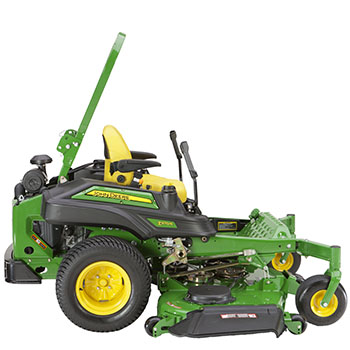 Z970R ZTrak™ Mower
Z970R ZTrak™ Mower

The durability features of the frame are as follows:
-
Heavy-duty, thick-gauge, steel channel mainframe for strength and durability
-
Cast I-beam caster arms to handle the beating and pounding professional mowers receive
-
Wide-open access for maintenance and cleaning
Two-piece rear bumper provides protection
 Illustration of ZTrak™ mower rear bumper
Illustration of ZTrak™ mower rear bumper
A steel rear bumper provides protection for the machine. The bumper is made of two pieces, making it easy to remove and install when using a material collection system (MCS).
A rear hitch can be added to the steel bumper for towing purposes. ZTrak E, M, and R Series Mowers can tow up to 400 lb (181.4 kg).
Michelin® X® Tweel® Turf airless radial tire technology for ZTrak™ Mowers eliminates downtime and reduces cost of operation
 Flat-free rear tire shown on ZTrak™ Mower
Flat-free rear tire shown on ZTrak™ Mower
John Deere provides the commercial mower industry with the Michelin X Tweel Turf technology for Commercial ZTrak Mowers:
- 24x12N12 as an ordering option code for ZTrak Gas Mowers with 54 in., 60 in., and 72 in. (137-cm, 152-cm, and 183-cm) Mower Decks
- 24x12N12 is also available as base code equipment for ZTrak Gas Mowers with 54 in., 60 in., and 72 in. (137-cm, 152-cm, and 183-cm) Mower Decks (ordering information available at Configurator on the Tweel model page)
- 24x12N12 as an ordering option code for ZTrak Z994R Diesel with 54 in. and 60 in. (137-cm and 152-cm) Mower Decks
- 26x12N12 as an ordering option code for Z997R Diesel with 60 in. and 72 in. (152-cm and 183-cm) Mower Decks
Michelin is a world leader in tire manufacturing and technology. This airless radial tire solution is an industry first for John Deere, which provides an additional advantage to John Deere customers.
Advantages of the Michelin X Tweel Turf include:
- Mowing performance is improved.
- Rutting is reduced because the Michelin X Tweel Turf has more support across the surface for improved flotation and better ground contact.
- Unique energy transfer within the poly-resin spokes reduces the bounce associated with pneumatic tires.
- Excellent curb climbing is possible due to the Michelin X Tweel Turf construction and flexibility.
- More consistent cut quality is achieved because inconsistent tire pressure is eliminated.
- Uptime is improved.
- The exclusive technology eliminates downtime and associated cost due to flat or damaged tires.
- Punctures and sidewall damage no longer result in downtime.
- Cost of operation is reduced.
- Cost of repairs and maintenance is reduced. One single unit replaces the current tire, wheel, and valve assembly. There is no need for complex tire-mounting equipment.
- No need to spend time checking and optimizing tire pressure.
- The need to purchase and stock plug kits and spare tires is eliminated, particularly for professional landscape contractors and government agencies who normally stock them.
- The tire tread will last up to three times longer than current pneumatic tires because automotive-grade rubber is used for the tread.
 Michelin X Tweel Turf
Michelin X Tweel Turf
 Michelin X Tweel Turf
Michelin X Tweel Turf
Heavy-duty construction provides the ultimate in performance and reliable operation:
- High-strength poly-resin spokes carry the load.
- Four-hole, heavy-duty steel hub for durability.
- Deep, open-tread design provides excellent cleaning and traction.
- Zero degree, high-tensile proprietary carcass provides great lateral stiffness while resisting damage from impact and penetration.
NOTE: In some cases different size Tweels are required depending on the mowing deck size.
Tires deliver exceptional traction and maneuverability
 Drive tire
Drive tire
 Front caster tire
Front caster tire
The ZTrak™ M Series Mowers with 48-in. (122-cm) mower decks come with 24x9.5-12 4 PR drive tires. M Series Mowers with 54-in. (137-cm), 60-in. (152-cm), and 72-in. (183-cm) decks come with 24x12-12 4 PR drive tires. All M Series Mowers are equipped with 13x6.5-6 front flat-free semi-pneumatic caster tires for the following:
- Excellent traction, flotation, and curb climbing
- Low center of gravity to increase hillside mowing capability
- Caster wheels and caster wheel towers with sealed bearings for long life and easy steering
- Offset front caster wheels to help improve the inside corner-trim performance and also reduce between-blade striping
Powerful 25-hp (18.6-kW), commercial-grade, electronically-fuel-injected (EFI) engine delivers class-leading performance and efficiency
 Z945M EFI electronic fuel injection engine shown
Z945M EFI electronic fuel injection engine shown
The Z925M EFI Mower is powered by an air-cooled, vertical-shaft, electronic fuel injection engine:
- 25-hp (18.6-kW) gas engine
Engine features include:
- Electronic, closed-loop electronic fuel injection system with oxygen sensor
- Up to 25 percent better fuel economy than typical carbureted engines of similar power
- Cleaner emissions
- Easier starting
- No choke control or cable
- Better recovery under load
- Automatic optimization for altitude (air pressure), air temperature, engine temperature, and fuel blends up to E10
- Onboard diagnostics (blink codes) and plug-in diagnostics (Service ADVISOR™ system) for EFI system trouble codes
- Overhead valve design
- More horsepower and torque per cubic inch of displacement
- Better fuel efficiency
- Full-pressure lubrication with full-flow filter
- Reduces engine wear by ensuring proper lubrication, even when operating on hillsides or uneven terrain
- Oil filter helps keep oil clean for increased engine life
- V-twin big block design
- Vertical shaft
- Easy-access, dual-element air filter
- 20-amp alternator
- Electric fuel pump
- Complies with strict U.S. Environmental Protection Agency (EPA) emission standards without loss of horsepower or torque
- Aluminum block engines
- Effectively dissipate heat
- Lightweight and strong construction
- Extend engine life due to elimination of debilitating engine temperatures
- Air-cooled engine design
Air cleaner filters out dust that can damage an engine
 Engine air cleaner
Engine air cleaner
 Air cleaner cover removed
Air cleaner cover removed
ZTrak™ Z900 Mowers are equipped with a dual-element, canister-style air filter, easily accessible from the rear of the machine without tools.
- The filtration system pulls clean air from above the engine, in turn filtering out the dust that can damage an engine over time.
- Filters are extremely easy to change when required.
- Pre-cleaner provides more protection against contamination in dusty and dirty applications.
Mow all day on a single tank of fuel with efficient and easy-to-fill fuel tank
 Fuel tank and filler neck
Fuel tank and filler neck
 Fuel filler neck
Fuel filler neck
The ZTrak™ Z900 Mowers are equipped with one single-fill, top-draw fuel tank:
- 11.5-U.S. gal. (43.5-L) capacity enables operators to mow all day without refueling.
- The fuel gauge makes it quick and easy to see how much fuel is in the tank.
- Top draw provides added safety.
- A large fuel-filler neck is angled to make it easy for an operator to complete the fueling process.
Under normal conditions, load, and operation, fuel consumption for the Z900 ZTrak Mowers is 1.5 U.S. gph (5.7 L/hr) to 2.2 U.S. gph (8.3 L/hr), depending on the horsepower and conditions.
Durable hydrostatic drive train that delivers better cooling and provides easy access
 Heavy-duty ground drive
Heavy-duty ground drive
The hydrostatic drive features two 13-cc (0.8-cu in.) unitized hydraulic pumps combined with commercial-grade, heavy-duty wheel motors into a single unit.
One pump and one motor drive each wheel on the ZTrak™ E and M Series Mowers. This provides several benefits:
- Exceptional cooling in high-load conditions
- Easy-to-check level and refill hydraulic oil
- Opens up access under the seat
Three seat choices with ComfortGlide™ fore/aft suspension offer exceptional operator comfort
There are three seating options available for the M and R Series, all of which are factory installed :
- Deluxe comfort seat with armrests
- Deluxe comfort seat with armrests and isolation
- Fully-adjustable suspension seat with armrests
ComfortGlide fore/aft suspension
 ComfortGlide fore/aft suspension control lever
ComfortGlide fore/aft suspension control lever
Each seat has the ComfortGlide fore/aft suspension system that gives superior ride comfort over uneven areas:
- Seat can travel up to 2 in. (50.8 mm) fore and aft to absorb bumps for a significant enhancement to ride comfort.
- Control lever provides the ability to easily lock out fore/aft suspension movement if desired.
- One lever has three functions.
- Slide seat forward and back 3 in. (10.2 cm) to allow the operator the ability to choose the leg room needed
- Activate ComfortGlide fore/aft seat suspension
- Lock out ComfortGlide fore/aft seat suspension
Deluxe comfort seat with armrests
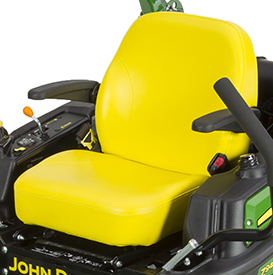 Deluxe comfort seat with armrests
Deluxe comfort seat with armrests
The deluxe comfort seat with armrests is standard on all E, M, and R Series models:
- Rubber springs are provided to increase ride comfort.
- A convenient seat latch makes it easy to lift the seat.
- The seat is factory installed.
Deluxe comfort seat with armrests and isolation
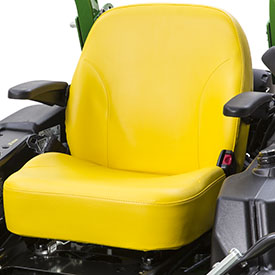 Deluxe comfort seat with armrests and isolation
Deluxe comfort seat with armrests and isolation
 Rubber isolation mount
Rubber isolation mount
The deluxe comfort seat with armrests and isolation is available on the E, M, and R Series:
- Rubber springs are provided to isolate the seat base and to increase ride comfort.
- A convenient seat latch makes it easy to lift the seat.
- Isolation mounting is a good feature to reduce vibration for operators who do not require the fully-adjustable suspension seat option.
- Factory installed on Z900s ordered with the deluxe comfort seat with armrests and isolation option.
Fully-adjustable suspension seat with armrests
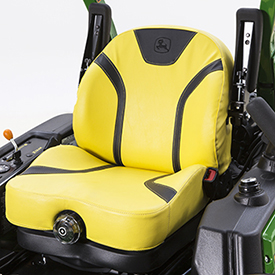 Fully-adjustable, mechanical suspension-seat
Fully-adjustable, mechanical suspension-seat
 Suspension seat control
Suspension seat control
A fully-adjustable suspension seat with armrests option is available on the M and R Series:
- Adjustable back angle is provided for individual operator comfort.
- Adjustable lumbar support to suit the needs of the operator.
- A suspension seat control dial gives easy adjustment for operator weight and ride comfort.
- A convenient seat latch for ease of lifting the seat
- On Z900s ordered with the fully-adjustable suspension seat with armrests option, it is factory installed.
Designed for operator comfort
 Operator station
Operator station
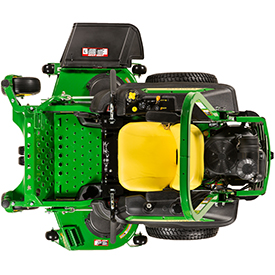 Top view
Top view
Two-lever hydrostatic control provides the following:
- Allows the operator to select the ground speed and direction control simply by moving levers forward or reverse.
- Positive neutral lock position for levers provides added safety.
- Brake & Go operator-presence system returns levers to the neutral position when the brake pedal is actively engaged.
- Starting the machines are as easy as starting a car. It no longer matters if the control levers are extended out or pulled in, as long as the parking brake is engaged. Just turn the key and go.
- Wide-bend, large-diameter steering levers swing out easily for entry and exit from the operator platform.
Brake & Go starting system
 Parking brake pedal (Z900R Series)
Parking brake pedal (Z900R Series)
 Parking brake lever (Z900 E and M Series)
Parking brake lever (Z900 E and M Series)
The Brake & Go starting system is a John Deere exclusive. This feature makes the starting process on all ZTrak™ mowers easier, while also making it possible to remove two interlock switches from the machine.
The Brake & Go starting procedure helps a novice operator look and feel like a professional. To start the machine, the parking brake must be engaged. It does not matter whether the power take-off (PTO) switch is on or off, nor does it matter if the control levers are pulled in or in the out position.
As long as the parking brake is engaged, the machine will start. When the parking brake is applied, the control levers cannot be moved to the forward or reverse positions.
Onboard storage and cup holder
 Onboard storage
Onboard storage
 Cup holder
Cup holder
Several storage areas are provided on the ZTrak machines. A convenient cup holder is also available.
Adjustable levers
 Adjustable levers
Adjustable levers
The motion control levers have two height positions and can also be adjusted forward or rearward within the slotted holes. The levers should be adjusted so the operator can achieve a full range of control operation comfortably.
Tracking adjustment
 Tracking adjustment
Tracking adjustment
The easy-to-turn (from-the-seat) tracking adjustment allows operators to keep their mowers straight and able to produce professional striping results.
Right-hand control panel
 Right-hand control panel
Right-hand control panel
 Right-hand control panel
Right-hand control panel
The controls are grouped together on the right console, providing one central location for key switch, throttle, PTO engagement, height-of-cut, diagnostics, and hourmeter.
- Rocker-type PTO switch
- Height-of-cut knob with transport lock
- Key switch
- Hourmeter
- Throttle
- Separate choke control
- Easy choke operation yields less fouling of plugs
- No choke required for the EFI models
Easy-to-operate height-of-cut adjustment enables on-the-go changes
 Mower deck height adjustment knob
Mower deck height adjustment knob
An easy-to-use cutting-height lift system allows the operator to adjust the mower deck height with no tools and minimal effort. The easy-to-grip knob allows operators to dial in the desired height of cut (HOC).
Cutting height can be adjusted from approximately 1 in. to 5.5 in. (2.5 cm to 14 cm). Each increment on the knob adjusts the HOC approximately 0.25 in. (0.64 cm). The deck can also be raised and locked in a transport position to provide maximum ground clearance when moving the machine from one area to another.
The transport lock function allows the deck to be returned to the previous HOC after being in the transport position:
- Use the foot-lift pedal to lift the deck and engage the transport lock.
- Rotate the knob to adjust from 1 in. to 5.5 in. (2.5 cm to 14 cm) in 0.25-in. (0.64 cm) increments.
This design increases productivity by allowing operators to change the cutting height without having to leave the seat.
Mower is easy to service with many accessible components
 Z945M EFI front view
Z945M EFI front view
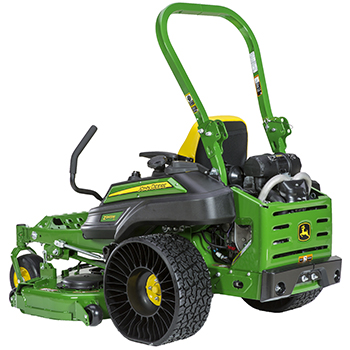 Z945M EFI rear view
Z945M EFI rear view
The design of the Z900 Series makes many service components reachable and easily accessible from the ground.
- Large, open engine compartment at the rear of the machine provides convenient servicing and ensures the engine heat is directed away from the operator.
 Flip-up foot panel
Flip-up foot panel
 Flip-up seat
Flip-up seat
Onboard maintenance chart
 Maintenance chart
Maintenance chart
All ZTrak™ Mowers come with an onboard maintenance chart that is conveniently located inside the right-hand console. The service interval chart gives necessary service intervals.
Diagnostics
 Hourmeter (M Series pictured)
Hourmeter (M Series pictured)
 Diagnostic chart
Diagnostic chart
The hourmeter shows the number of hours the machine is run when the key switch is in the on position. It only counts the hours the engine is actually running. Machine diagnostics are the first step of a monitoring system to help operators quickly diagnose common downtime issues. A trouble code light is included on the hourmeter.
Use of the hourmeter and service interval chart helps determine when the machine will need service.
Rollover protective structure (ROPS) enhances operator safety
 ROPS up
ROPS up
 ROPS mid position
ROPS mid position
 ROPS down position
ROPS down position
The ZTrak™ Z900E, M, and R Series Mowers are equipped with a standard two-post folding ROPS and seat belt. The folding ROPS enhances operator safety and provides ample clearance when storing the mower in garages or sheds:
- ISO21299 certification
- Foldable
The ROPS system can be repositioned without the use of tools. Under normal operation, the ROPS should be in the up position. If operating in low clearance areas, they can be folded and secured out of the way. The ROPS can also be pinned halfway down to accommodate machines equipped with a material collection system.
Three-year, bumper-to-bumper warranty
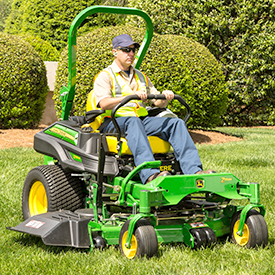 Z930M ZTrak Mower
Z930M ZTrak Mower
 Z970R ZTrak Mower
Z970R ZTrak Mower
E and M Series three-year, 1200-hour bumper-to-bumper warranty
An exclusive two-year, unlimited hour/three-year, 1200-hour (whichever comes first) bumper-to-bumper warranty is standard for all John Deere E and M Series Mowers. The warranty is best in its class and places John Deere at the forefront of commercial mowing. It is also hassle free, with one company handling all of the paperwork.
NOTE: 36 months or 1200 hours, whichever comes first. For the first 24 months, there is no hour limitation.
R Series three-year, 1500-hour bumper-to-bumper warranty
An exclusive two-year, unlimited hour/three-year, 1500-hour (whichever comes first) bumper-to-bumper warranty is standard on all John Deere R Series mowers. The warranty is best in the industry and puts John Deere at the forefront of commercial mowing. It is also hassle free, with one company handling all of the paperwork.
NOTE: 36 months or 1500 hours, whichever comes first. For the first 24 months, there is no hour limitation.
Mower decks are safety certified
 Z950M ZTrak™ Mower
Z950M ZTrak™ Mower
Mowers decks are evaluated by the manufacturer (John Deere Turf Care) and conform to American National Standards Institute (ANSI) B71.4 2004 safety certification specifications for commercial turf care equipment.
Durable 7-Iron™ PRO decks pressed from a single piece of steel
 72-in. (183-cm) 7-Iron PRO deck shown
72-in. (183-cm) 7-Iron PRO deck shown
The ZTrak™ M and R Series Mowers are equipped with either a side-discharge or Mulch On Demand™ 7-Iron PRO deck.
7-Iron PRO mower decks have demonstrated quality, performance, and durability. They deliver a high quality cut in diverse conditions.
Key features of the 7-Iron PRO mower deck:
- Deck is stamped from 7-gauge, 0.179-in. (4.6-mm) steel to minimize the number of welds and provide a smooth underside with fewer sharp corners for reduced material buildup.
- Significantly fewer welds on the deck shell to wear or break - it is stamped from a single sheet of steel rather than multiple fabrications. An anti-skid step on the deck provides easy machine mounting.
- Higher blade tip speed than many competitors - 18,500 fpm (5,639 m/min) for more blade cuts per inch mowed.
- A deep-deck design of 5.5 in. (14 cm) delivers excellent airflow so material can be processed quickly and efficiently.
- The wider and higher discharge opening provides even clipping dispersal for an excellent finished appearance in all conditions.
 Mower rectangular leading-edge reinforcement
Mower rectangular leading-edge reinforcement
 Dual-captured anti-scalp wheel
Dual-captured anti-scalp wheel
Key features of the 7-Iron PRO mower deck:
- Deck has rectangular leading deck edge reinforcement and the rounded corners of the stamped deck help distribute impact stress to reduce the potential of damage when the mower contacts trees, rocks, curbs, and other fixed obstacles.
- Dual-captured front and rear anti-scalp wheels provide deck flotation over even the toughest terrain.
- Three 1-in. (2.5-cm), cold-forged spindles are heat-treated for strength without bulk and are supported by ball bearings, providing reliability and performance; spindle housings are ribbed cast aluminum providing both excellent strength and heat dissipation.
- The front edge is raised above the blade plane to allow even cutting of tall grass and is reinforced with a square bar for durability. The front baffle has been redesigned to better manage airflow and control clippings.
- Three spindle grease fittings are accessible from the top.
- Blade overlap is 1.6 in. (40.6 mm), nearly 0.79 in. (20 mm) greater than previous decks, to reduce striping between blades.
- Quick-change, cutting-height adjustment.
7-Iron PRO mower deck
| M Series | R Series |
| Z920M - 48 in. (122 cm), 54 in. (137 cm), 60 in. (152 cm) | Z930R - 54 in. (137 cm), 60 in. (152 cm) |
| Z925M EFI - 54 in. (137 cm), 60 in. (152 cm) | Z950R - 60 in. (152 cm), 72 in. (183 cm) |
| Z930M - 54 in. (137 cm), 60 in. (152 cm) | Z970R - 60 in. (152 cm), 72 in. (183 cm) |
| Z945M EFI - 60 in. (152 cm) | |
| Z950M - 60 in. (152 cm), 72 in. (183 cm) | |
| Z955M EFI - 60 in. (152 cm), 72 in. (183 cm) | |
| Z960M - 60 in. (152 cm), 72 in. (183 cm) |
 Mower deck step shown on 72-in. (183-cm) mower
Mower deck step shown on 72-in. (183-cm) mower
The deck step safely aids the operator's entrance and egress from machine.
Available Mulch On Demand™ deck
 Mulch On Demand mower deck
Mulch On Demand mower deck
 Mower deck with chute closed
Mower deck with chute closed
The Mulch On Demand mower deck delivers unprecedented levels of productivity and versatility to commercial mower operation. With the ability to switch between side discharge and mulching operation with the flip of a lever as the operator mows, keeping most clippings out of landscaping features and where they are wanted is extremely easy.
 Mulch On Demand open
Mulch On Demand open
![Mulch On Demand closed (latch standard on material collection system [MCS] equipped models only)](https://salesmanual.deere.com/sales/salesmanual/images/NA/commercial_mowers/features_attachment/ztraks_com/480295_mod_deck_oval_275x175.jpg) Mulch On Demand closed (latch standard on material collection system [MCS] equipped models only)
Mulch On Demand closed (latch standard on material collection system [MCS] equipped models only)
 Lever position open (latch standard on MCS-equipped models only)
Lever position open (latch standard on MCS-equipped models only)
 Lever position closed
Lever position closed
Key features of the 7-Iron™ PRO Mulch On Demand mower deck:
- Deck can be converted from a wide-open side discharge mode to a fully chambered mulching mode with a single move of a lever.
- NOTE: Mulch On Demand decks are a balance between a side discharge deck and a side discharge deck with a mulching kit.
- Deck is stamped from 7-gauge, 0.179-in. (4.6-mm) steel to minimize the number of welds and provide a smooth underside, with fewer sharp corners, for reduced material buildup.
- Significantly fewer welds on the deck shell to wear or break- it is stamped from a single sheet of steel rather than multiple fabrications. Anti-skid step on the deck provides for easy machine mounting.
- Mulch On Demand decks are superior to aftermarket chute blockers due to the movable baffles.
- Higher blade tip speed than many competitors - 18,500 fpm (5,639 m/min) for more blade cuts per inch mowed.
- Rounded corners of the stamped deck help distribute impact stress to reduce the potential of damage when the mower contacts trees, rocks, curbs, and other fixed obstacles.
- Deep-deck design of 5.5 in. (14 cm) delivers excellent airflow so material can be processed quickly and efficiently.
- Wider and higher discharge opening provides even clipping dispersal for an excellent finished appearance in all conditions.
- Three 1-in. (2.5 cm) cold-forged spindles are heat-treated for strength without bulk and are supported by ball bearings, providing reliability and performance; spindle housings are ribbed cast aluminum providing both excellent strength and heat dissipation.
- The front edge is raised above the blade plane to allow even cutting of tall grass and reinforced with a square bar for durability. The front baffle has been redesigned to better manage airflow and control clippings.
- Dual-captured anti-scalp wheels provide deck flotation over even the toughest terrain.
- Three greasable spindle zerks accessible from the top.
- Blade overlap is 1.6 in. (40 mm), nearly 0.79 in. (20 mm) greater than previous decks, to reduce striping between blades.
- Quick-change, cutting-height adjustment.
7-Iron PRO Mulch On Demand mower deck
| M Series | R Series |
| Z920M - 48-in. (122-cm) Mulch On Demand | Z930R - 54-in. (137-cm) Mulch On Demand |
| Z925M EFI - 54-in. (137-cm) Mulch On Demand | Z950R - 60-in. (152-cm) Mulch On Demand |
| Z930M - 54-in. (137-cm) Mulch On Demand Z930M - 60-in. (152-cm) Mulch On Demand |
Z970R - 60-in. (152-cm) Mulch On Demand |
| Z945M EFI - 60-in. (152-cm) Mulch On Demand | |
| Z950M - 60-in. (152-cm) Mulch On Demand | |
| Z955M EFI - 60-in. (152-cm) Mulch On Demand | |
| Z960M - 60-in. (152-cm) Mulch On Demand |
Spindle assembly provides greater performance and reliability
 Spindle assembly
Spindle assembly
On every John Deere ZTrak™ mower deck, there are three 1-in. (2.5-cm) spindles that are cold-forged and heat-treated for strength without bulk. The spindles are supported by precision ball bearings, providing great performance and reliability.
The spindle housing is made of aircraft-grade, ribbed cast aluminum. This unique casting design embosses reinforcing gussets in the housing, which adds both strength and cooling surface area that stands up to commercial applications.
These spindles can be greased from the top and require no disassembly to reach. Grease channels provide lubrication to both bearings.
Features
Heavy-duty frame provides strength and durability
 Z955R EFI model shown with optional X® Tweel® Turf airless radial tire technology
Z955R EFI model shown with optional X® Tweel® Turf airless radial tire technology

The durability features of the frame are as follows:
-
Heavy-duty, thick-gauge, steel channel mainframe for strength and durability
-
Cast I-beam caster arms to handle the beating and pounding professional mowers receive
-
Wide-open access for maintenance and cleaning
Two-piece rear bumper provides protection
 Illustration of ZTrak™ mower rear bumper
Illustration of ZTrak™ mower rear bumper
A steel rear bumper provides protection for the machine. The bumper is made of two pieces, making it easy to remove and install when using a material collection system (MCS).
A rear hitch can be added to the steel bumper for towing purposes. ZTrak E, M, and R Series Mowers can tow up to 400 lb (181.4 kg).
Michelin, X, and Tweel are trademarks of Michelin North America, Inc.
Michelin® X® Tweel® Turf airless radial tire technology for ZTrak™ Mowers eliminates downtime and reduces cost of operation
 Flat-free rear tire shown on ZTrak™ Mower
Flat-free rear tire shown on ZTrak™ Mower
John Deere provides the commercial mower industry with the Michelin X Tweel Turf technology for Commercial ZTrak Mowers:
- 24x12N12 as an ordering option code for ZTrak Gas Mowers with 54 in., 60 in., and 72 in. (137-cm, 152-cm, and 183-cm) Mower Decks
- 24x12N12 is also available as base code equipment for ZTrak Gas Mowers with 54 in., 60 in., and 72 in. (137-cm, 152-cm, and 183-cm) Mower Decks (ordering information available at Configurator on the Tweel model page)
- 24x12N12 as an ordering option code for ZTrak Z994R Diesel with 54 in., 60 in., and 72 in. (137-cm, 152-cm, and 183 cm) Mower Decks
- 26x12N12 as an ordering option code for Z997R Diesel with 60 in. and 72 in. (152-cm and 183-cm) Mower Decks
Michelin is a world leader in tire manufacturing and technology. This airless radial tire solution is an industry first for John Deere, which provides an additional advantage to John Deere customers.
Advantages of the Michelin X Tweel Turf include:
- Mowing performance is improved.
- Rutting is reduced because the Michelin X Tweel Turf has more support across the surface for improved flotation and better ground contact.
- Unique energy transfer within the poly-resin spokes reduces the bounce associated with pneumatic tires.
- Excellent curb climbing is possible due to the Michelin X Tweel Turf construction and flexibility.
- More consistent cut quality is achieved because inconsistent tire pressure is eliminated.
- Uptime is improved.
- The exclusive technology eliminates downtime and associated cost due to flat or damaged tires.
- Punctures and sidewall damage no longer result in downtime.
- Cost of operation is reduced.
- Cost of repairs and maintenance is reduced. One single unit replaces the current tire, wheel, and valve assembly. There is no need for complex tire-mounting equipment.
- No need to spend time checking and optimizing tire pressure.
- The need to purchase and stock plug kits and spare tires is eliminated, particularly for professional landscape contractors and government agencies who normally stock them.
- The tire tread will last up to three times longer than current pneumatic tires because automotive-grade rubber is used for the tread.
 Michelin X Tweel Turf
Michelin X Tweel Turf
 Michelin X Tweel Turf
Michelin X Tweel Turf
Heavy-duty construction provides the ultimate in performance and reliable operation:
- High-strength poly-resin spokes carry the load.
- Four-hole, heavy-duty steel hub for durability.
- Deep, open-tread design provides excellent cleaning and traction.
- Zero degree, high-tensile proprietary carcass provides great lateral stiffness while resisting damage from impact and penetration.
NOTE: In some cases, different size Tweel tires are required depending on the mower deck size.
Tires deliver exceptional traction and maneuverability
 Drive tire
Drive tire
 Front caster tire
Front caster tire
The ZTrak M Series Mowers with 48-in. (122-cm) mower decks come with 24x9.5-12 4 PR drive tires. M Series Mowers with 54-in. (137-cm), 60-in. (152-cm), and 72-in. (183-cm) decks come with 24x12-12 4 PR drive tires. All M Series Mowers are equipped with 13x6.5-6 front flat-free semi-pneumatic caster tires for the following:
- Excellent traction, flotation, and curb climbing
- Low center of gravity to increase hillside mowing capability
- Caster wheels and caster wheel towers with sealed bearings for long life and easy steering
- Offset front caster wheels to help improve the inside corner-trim performance and also reduce between-blade striping
Michelin, X, and Tweel are trademarks of Michelin North America, Inc.
Powerful 23.5-hp (17.5-kW) commercial-grade engine delivers class-leading performance and efficiency
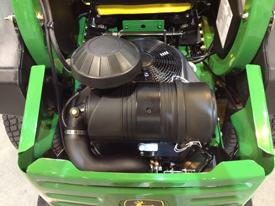 Z920M engine
Z920M engine

The Z920M is powered by an air-cooled, vertical shaft engine:
- 23.5-hp (17.5-kW) gas engine
Engine features include:
- Overhead valve design
- More horsepower and torque per cubic inch of displacement
- Better fuel efficiency
- Full-pressure lubrication with full-flow filter
- Reduces engine wear by ensuring proper lubrication, even when operating on hillsides or uneven terrain
- Oil filter helps keep oil clean for increased engine life
- V-twin big block design
- Vertical shaft
- Easy-access, dual-element air filter with quick release latch
- 20-amp alternator
- Fuel pump
- Aluminum block engines
- Effectively dissipate heat
- Lightweight and strong construction
- Extend engine life due to elimination of debilitating engine temperatures
- Air-cooled engine design
Air cleaner filters out dust that can damage an engine
 Engine air cleaner
Engine air cleaner
 Air cleaner cover removed
Air cleaner cover removed
ZTrak™ Z900 Mowers are equipped with a dual-element, canister-style air filter, easily accessible from the rear of the machine without tools.
- The filtration system pulls clean air from above the engine, in turn filtering out the dust that can damage an engine over time.
- Filters are extremely easy to change when required.
- Pre-cleaner provides more protection against contamination in dusty and dirty applications.
Mow all day on a single tank of fuel with efficient and easy-to-fill fuel tank
 Fuel tank and filler neck
Fuel tank and filler neck
 Fuel filler neck
Fuel filler neck
The ZTrak Z900 Mowers are equipped with one single-fill, top-draw fuel tank:
- 11.5-U.S. gal. (43.5-L) capacity enables operators to mow all day without refueling.
- The fuel gauge makes it quick and easy to see how much fuel is in the tank.
- Top draw provides added safety.
- A large fuel-filler neck is angled to make it easy for an operator to complete the fueling process.
Under normal conditions, load, and operation, fuel consumption for the Z900 ZTrak Mowers is 1.5 U.S. gph (5.7 L/hr) to 2.2 U.S. gph (8.3 L/hr), depending on the horsepower and conditions.
Field-installed propane conversion kits for Commercial Walk-Behind Mowers, QuikTrak™ Mowers, and Commercial ZTrak™ Mowers
 Propane conversion kit on a Walk-Behind Mower
Propane conversion kit on a Walk-Behind Mower
 Propane conversion kit on a ZTrak Mower
Propane conversion kit on a ZTrak Mower
John Deere provides application-specific Environmental Protection Agency (EPA) approved field-installed propane conversion kits for specific John Deere Commercial Walk-Behind Mowers, QuikTrak Mowers, and ZTrak Mowers. The conversion kits include all components required to convert the engines to operate on propane fuel. Single-tank or dual-tank brackets (depending on the vehicle) are provided for securely holding the propane tank(s) to the vehicle.
Propane tanks are not included.
An optional altitude kit is required when operating at altitudes above 2000 ft (610 m). The operator’s manual with the propane conversion kit provides further details. Parts must be ordered separately through John Deere Parts.
Propane facts:
- Propane is flammable and commonly used as a fuel.
- The molecular formula of propane is C3H8, and it is in the family of liquefied petroleum gases (LP gases). The other LP gases include butane, propylene, butadiene, butylene, isobutylene, and mixtures thereof.
- Propane is commonly available and has proven to be a dependable, safe, economical, and clean-burning fuel. It can be used as household fuel, industrial fuel, and fuel for internal combustion engines. Propane has been used as a fuel since 1910.
- At atmospheric pressure, propane boils at -44°F (-42.2°C), meaning it typically exists as a vapor. However, when contained under pressure, such as in a propane cylinder, it can exist as a liquid.
- Propane is naturally odorless, but includes an additive odorant, usually mercaptan, which gives it a distinct odor.
- Vapor propane is heavier than air, meaning it will settle in low areas such as along the ground or in drains.
Advantages of John Deere propane conversion kits include:
- Reduced fuel costs, up to 30 percent depending on fuel prices
- Lower emissions
- Reduced fuel-system maintenance
- Maintains John Deere warranty
- EPA and CARB certified
- May qualify for national and state rebate and incentive programs. Please visit www.propane.com/commercial-landscape/programs-and-incentives/ for further information.
Propane tank mounting bracket options:
 Single propane tank shown on QuikTrak Mower
Single propane tank shown on QuikTrak Mower
 Dual propane tanks shown on ZTrak Mower
Dual propane tanks shown on ZTrak Mower
Optional tank configurations and sizes are available to provide operators the ability to tailor for run time:
- Commercial Walk-Behind Mowers have only a single-tank mounting option.
- The single-tank bracket is designed for one 20-lb (9.1-kg) or 33-lb (15-kg) Worthington tank.
- Tank is not included.
- The single-tank bracket is designed for one 20-lb (9.1-kg) or 33-lb (15-kg) Worthington tank.
- QuikTrak Mowers have single-tank and dual-tank mounting options.
- The single-tank, right-side bracket is designed for one 33-lb (15-kg) Worthington tank.
- Tank is not included.
- The dual-tank brackets are designed for two 20-lb (9.1-kg) Worthington tanks.
- Tanks are not included.
- The single-tank, right-side bracket is designed for one 33-lb (15-kg) Worthington tank.
- ZTrak Mowers have single-tank and dual-tank mounting options.
- The single-tank, left-side bracket is designed for one 33-lb (15-kg) or 43-lb (19.5-kg) Worthington tank.
- Tank is not included.
- The dual-tank brackets are designed for two 33-lb (15-kg) Worthington tanks.
- Tanks are not included.
- ZTrak Mowers with dual-tank configurations are not compatible with any material collection systems.
NOTE: Reference the Propane and Attachment Compatibility Chart to determine tank configurations that are compatible.
Estimated run-time comparison
| Engine displacement | FS603cc | FS726cc | FX726cc | FX852cc |
| Average consumption (lb [kg]/hr) | 3.9 (1.8) | 4.2 (1.9) | 4.2 (1.9) | 5.8 (2.6) |
| Run time (hours) with 20-lb (9.1-kg) tank | 5.1 | 4.8 | 4.8 | 3.4 |
| Run time (hours) with 33.5-lb (15.2-kg) tank | Not available | 8.0 | 8.0 | 5.8 |
| Run time (hours) with 43.5-lb (19.7-kg) tank | Not available | 10.4 | 10.4 | 7.5 |
Field-installed propane conversion kit compatibility:
NOTE: Conversion to propane is not intended for units with engines having more than 250 hours of use.
Commercial Walk-Behind Mowers (model year 2018 and prior)
| WG Series | WH Series | WHP Series | |||||||||
| Model | WG32A | WG36A | WG48A | WH36A | WH48A | WH52A | WH61A | WHP36A | WHP48A | WHP52A | WHP61A |
| Engine model | FS481V | FS481V | FS481V | FS481V | FS600V | FS600V | FS691V | FS481V | FS600V | FS600V | FS691V |
| Engine displacement | 603 cc | 603 cc | 603 cc | 603 cc | 603 cc | 603 cc | 726 cc | 603 cc | 603 cc | 603 cc | 726 cc |
| Propane kit model number | Not available | Not available | Not available | FS603cc | FS603cc | FS603cc | FS726cc | FS603cc | FS603cc | FS603cc | FS726cc |
QuikTrak Mowers
| E Series | M Series | R Series | |||||||
| Model | 652E | 636M | 648M | 652M | 648R | 652R | 652R EFI | 661R | 661R EFI |
| Engine model | FX691V | FS600V | FX691V | FX691V | FX691V | FX730V | ECV740 EFI | FX730V | ECV740 EFI |
| Engine displacement | 726 cc | 603 cc | 726 cc | 726 cc | 726 cc | 726 cc | 747 cc | 726 cc | 747 cc |
| Propane kit model number | FX726cc | Not available | Not available | Not available | FX726cc | FX726cc | Not available | FX726cc | Not available |
Commercial ZTrak Mowers
| E Series | M Series | R Series | |||||||||
| Model | Z915E | Z920M | Z930M | Z945M EFI | Z950M | Z955M EFI | Z960M | Z930R | Z950R | Z955R EFI | Z970R |
| Engine model | CV742 | FX730V | FX801V | ECV850 EFI | FX850V | ECV860J EFI | FX921V | FX801V | FX850V | ECV860J EFI | FX1000V |
| Engine displacement | 747 cc | 726 cc | 852 cc | 824 cc | 852 cc | 824 cc | 999 cc | 852 cc | 852 cc | 824 cc | 999 cc |
| Propane kit model number | Not available | FX726cc* | FX852cc* | Not available | FX852cc* | Not available | Not available | FX852cc* | FX852cc* | Not available | Not available |
Worthington tanks are manufactured by Worthington Industries, Inc.
Durable hydrostatic drive train that delivers better cooling and provides easy access
 Heavy-duty ground drive
Heavy-duty ground drive
The hydrostatic drive features two 13-cc (0.8-cu in.) unitized hydraulic pumps combined with commercial-grade, heavy-duty wheel motors into a single unit.
One pump and one motor drive each wheel on the ZTrak™ E and M Series Mowers. This provides several benefits:
- Exceptional cooling in high-load conditions
- Easy-to-check level and refill hydraulic oil
- Opens up access under the seat
Three seat choices with ComfortGlide™ fore/aft suspension offer exceptional operator comfort
There are three seating options available for the M Series, all of which are factory installed:
- Deluxe comfort seat with armrests
- Deluxe comfort seat with armrests and isolation
- Fully adjustable suspension seat with armrests
ComfortGlide fore/aft suspension
 ComfortGlide fore/aft suspension control lever
ComfortGlide fore/aft suspension control lever
Each seat has the ComfortGlide fore/aft suspension system that gives superior ride comfort over uneven areas:
- Seat can travel up to 2 in. (50.8 mm) fore and aft to absorb bumps for a significant enhancement to ride comfort.
- Control lever provides the ability to easily lock out fore/aft suspension movement if desired.
- One lever has three functions:
- Slide seat forward and back 3 in. (10.2 cm) to allow the operator the ability to choose the leg room needed
- Activate ComfortGlide fore/aft seat suspension
- Lock out ComfortGlide fore/aft seat suspension
Deluxe comfort seat with armrests
 Deluxe comfort seat with armrests
Deluxe comfort seat with armrests
The deluxe comfort seat with armrests is standard on all E and M Series models:
- Rubber springs are provided to increase ride comfort.
- A convenient seat latch makes it easy to lift the seat.
- The seat is factory installed.
Deluxe comfort seat with armrests and isolation
 Deluxe comfort seat with armrests and isolation
Deluxe comfort seat with armrests and isolation
 Rubber isolation mount
Rubber isolation mount
The deluxe comfort seat with armrests and isolation is available on the E, M, and R Series:
- Rubber springs are provided to isolate the seat base and to increase ride comfort.
- A convenient seat latch makes it easy to lift the seat.
- Isolation mounting is a good feature to reduce vibration for operators who do not require the fully adjustable suspension seat option.
- Factory installed on Z900s ordered with the deluxe comfort seat with armrests and isolation option.
Fully adjustable suspension seat with armrests
 Fully adjustable, mechanical suspension-seat
Fully adjustable, mechanical suspension-seat
 Suspension seat control
Suspension seat control
A fully adjustable suspension seat with armrests option is available on the M and R Series:
- Adjustable back angle is provided for individual operator comfort.
- Adjustable lumbar support helps to suit the needs of the operator.
- A suspension seat control dial gives easy adjustment for operator weight and ride comfort.
- A convenient seat latch provides ease of lifting the seat.
- On Z900s ordered with the fully adjustable suspension seat with armrests option, it is factory installed.
Designed for operator comfort
 Operator station
Operator station
Two-lever hydrostatic control provides the following:
- The operator can select the ground speed and direction control simply by moving levers forward or reverse.
- Positive neutral lock position for levers provides added safety.
- Brake & Go operator-presence system returns levers to the neutral position when the brake pedal is actively engaged.
- Starting the machines is as easy as starting a car. It no longer matters if the control levers are extended out or pulled in, as long as the parking brake is engaged. Just turn the key and go.
- Wide-bend, large-diameter steering levers swing out easily for entry and exit from the operator platform.
Onboard storage and cup holder
 Onboard storage
Onboard storage
 Cup holder
Cup holder
Several storage areas are provided on the ZTrak machines. A convenient cup holder is also available.
Brake & Go starting system
 Parking brake pedal (Z900R Series)
Parking brake pedal (Z900R Series)
 Parking brake lever (Z900 E and M Series)
Parking brake lever (Z900 E and M Series)
The Brake & Go starting system is a John Deere exclusive. This feature makes the starting process on all ZTrak™ mowers easier, while also making it possible to remove two interlock switches from the machine.
The Brake & Go starting procedure helps a novice operator look and feel like a professional. To start the machine, the parking brake must be engaged. It does not matter whether the power take-off (PTO) switch is on or off, nor does it matter if the control levers are pulled in or in the out position.
As long as the parking brake is engaged, the machine will start. When the parking brake is applied, the control levers cannot be moved to the forward or reverse positions.
Adjustable levers
 Adjustable levers
Adjustable levers
The motion control levers have two height positions and can also be adjusted forward or rearward within the slotted holes. The levers should be adjusted so the operator can achieve a full range of control operation comfortably.
Tracking adjustment
 Tracking adjustment
Tracking adjustment
The easy-to-turn (from-the-seat) tracking adjustment allows operators to keep their mowers straight and produce professional striping results.
Right-hand control panel
 Right-hand control panel
Right-hand control panel
 Right-hand control panel
Right-hand control panel
The controls are grouped together on the right console, providing one central location for key switch, throttle, PTO engagement, height-of-cut, diagnostics, and hour meter.
- Rocker-type PTO switch
- Height-of-cut knob with transport lock
- Key switch
- Hourmeter
- Throttle
- Separate choke control
- Easy choke operation yields less fouling of plugs
- No choke required for the electronic fuel injection (EFI) models
Easy-to-operate height-of-cut adjustment enables on-the-go changes
 Mower deck height adjustment knob
Mower deck height adjustment knob
An easy-to-use cutting-height lift system allows the operator to adjust the mower deck height with no tools and minimal effort. The easy-to-grip knob allows operators to dial in the desired height of cut (HOC).
Cutting height can be adjusted from approximately 1 in. to 5.5 in. (2.5 cm to 14 cm). Each increment on the knob adjusts the HOC approximately 0.25 in. (0.64 cm). The deck can also be raised and locked in a transport position to provide maximum ground clearance when moving the machine from one area to another.
The transport lock function allows the deck to be returned to the previous HOC after being in the transport position:
- Use the foot-lift pedal to lift the deck and engage the transport lock.
- Rotate the knob to adjust from 1 in. to 5.5 in. (2.5 cm to 14 cm) in 0.25-in. (0.64 cm) increments.
This design increases productivity by allowing operators to change the cutting height without having to leave the seat.
Mower is easy to service with many accessible components
 Z955R EFI left front view
Z955R EFI left front view
The design of the Z900 Series makes many service components reachable and easily accessible from the ground.
- Large, open engine compartment at the rear of the machine provides convenient servicing and ensures the engine heat is directed away from the operator.
 Flip-up foot panel
Flip-up foot panel
 Flip-up seat
Flip-up seat
Onboard maintenance chart
 Maintenance chart
Maintenance chart
All ZTrak™ Mowers come with an onboard maintenance chart that is conveniently located inside the right-hand console. The service interval chart gives necessary service intervals.
Diagnostics
 Hour meter (M Series pictured)
Hour meter (M Series pictured)
 Diagnostic chart
Diagnostic chart
The hour meter shows the number of hours the machine is run when the key switch is in the on position. It only counts the hours the engine is actually running. Machine diagnostics are the first step of a monitoring system to help operators quickly diagnose common downtime issues. A trouble code light is included on the hour meter.
Use of the hour meter and service interval chart helps determine when the machine will need service.
Rollover protective structure (ROPS) enhances operator safety
 ROPS up
ROPS up
 ROPS mid position
ROPS mid position
 ROPS down position
ROPS down position
The ZTrak™ Z900E, M, and R Series Mowers are equipped with a standard two-post folding ROPS and seat belt. The folding ROPS enhances operator safety and provides ample clearance when storing the mower in garages or sheds:
- ISO21299 certification
- Foldable
The ROPS system can be repositioned without the use of tools. Under normal operation, the ROPS should be in the up position. If operating in low clearance areas, they can be folded and secured out of the way. The ROPS can also be pinned halfway down to accommodate machines equipped with a material collection system.
Three-year, bumper-to-bumper warranty
 Z955M ZTrak™ Mower
Z955M ZTrak™ Mower
 Z955R ZTrak Mower
Z955R ZTrak Mower
E and M Series 3-year, 1200-hour bumper-to-bumper warranty
An exclusive 2-year, unlimited hour/3-year, 1200-hour (whichever comes first) bumper-to-bumper warranty is standard for all John Deere E and M Series Mowers. The warranty is best in its class and places John Deere at the forefront of commercial mowing. It is also hassle free, with one company handling all of the paperwork.
NOTE: 36 months or 1200 hours, whichever comes first. For the first 24 months, there is no hour limitation.
R Series 3-year, 1500-hour bumper-to-bumper warranty
An exclusive 2-year, unlimited hour/3-year, 1500-hour (whichever comes first) bumper-to-bumper warranty is standard on all John Deere R Series mowers. The warranty is best in the industry and puts John Deere at the forefront of commercial mowing. It is also hassle free, with one company handling all of the paperwork.
NOTE: 36 months or 1500 hours, whichever comes first. For the first 24 months, there is no hour limitation.
Mower decks are safety certified
 Z950M ZTrak Mower
Z950M ZTrak Mower
Mowers decks are evaluated by the manufacturer (John Deere Turf Care) and conform to American National Standards Institute (ANSI) B71.4 2004 safety certification specifications for commercial turf care equipment.
Durable 7-Iron™ PRO decks pressed from a single piece of steel
 72-in. (183-cm) 7-Iron PRO deck shown
72-in. (183-cm) 7-Iron PRO deck shown
The ZTrak™ M and R Series Mowers are equipped with either a side-discharge or Mulch On Demand™ 7-Iron PRO deck.
7-Iron PRO mower decks have demonstrated quality, performance, and durability. They deliver a high quality cut in diverse conditions.
Key features of the 7-Iron PRO mower deck:
- Deck is stamped from 7-gauge, 0.179-in. (4.6-mm) steel to minimize the number of welds and provide a smooth underside with fewer sharp corners for reduced material buildup.
- Significantly fewer welds on the deck shell to wear or break - it is stamped from a single sheet of steel rather than multiple fabrications. An anti-skid step on the deck provides easy machine mounting.
- Higher blade tip speed than many competitors - 18,500 fpm (5,639 m/min) for more blade cuts per inch mowed.
- A deep-deck design of 5.5 in. (14 cm) delivers excellent airflow so material can be processed quickly and efficiently.
- The wider and higher discharge opening provides even clipping dispersal for an excellent finished appearance in all conditions.
 Mower rectangular leading-edge reinforcement
Mower rectangular leading-edge reinforcement
 Dual-captured anti-scalp wheel
Dual-captured anti-scalp wheel
Key features of the 7-Iron PRO mower deck:
- Deck has rectangular leading deck edge reinforcement and the rounded corners of the stamped deck help distribute impact stress to reduce the potential of damage when the mower contacts trees, rocks, curbs, and other fixed obstacles.
- Dual-captured front and rear anti-scalp wheels provide deck flotation over even the toughest terrain.
- Three 1-in. (2.5-cm), cold-forged spindles are heat-treated for strength without bulk and are supported by ball bearings, providing reliability and performance; spindle housings are ribbed cast aluminum providing both excellent strength and heat dissipation.
- The front edge is raised above the blade plane to allow even cutting of tall grass and is reinforced with a square bar for durability. The front baffle has been redesigned to better manage airflow and control clippings.
- Three spindle grease fittings are accessible from the top.
- Blade overlap is 1.6 in. (40.6 mm), nearly 0.79 in. (20 mm) greater than previous decks, to reduce striping between blades.
- Quick-change, cutting-height adjustment.
7-Iron PRO mower deck
| M Series | R Series |
| Z920M - 48 in. (122 cm), 54 in. (137 cm), 60 in. (152 cm) | Z930R - 54 in. (137 cm), 60 in. (152 cm) |
| Z930M - 54 in. (137 cm), 60 in. (152 cm) | Z950R - 60 in. (152 cm), 72 in. (183 cm) |
| Z945M EFI - 60 in. (152 cm) | Z955R EFI - 60 in. (152 cm) |
| Z950M - 60 in. (152 cm), 72 in. (183 cm) | Z970R - 60 in. (152 cm), 72 in. (183 cm) |
| Z955M EFI - 60 in. (152 cm), 72 in. (183 cm) | |
| Z960M - 60 in. (152 cm), 72 in. (183 cm) |
 Mower deck step shown on 72-in. (183-cm) mower
Mower deck step shown on 72-in. (183-cm) mower
The deck step safely aids the operator's entrance and egress from machine.
Available Mulch On Demand™ deck
 Mulch On Demand mower deck
Mulch On Demand mower deck
 Mower deck with chute closed
Mower deck with chute closed
The Mulch On Demand mower deck delivers unprecedented levels of productivity and versatility to commercial mower operation. With the ability to switch between side discharge and mulching operation with the flip of a lever as the operator mows, keeping most clippings out of landscaping features and where they are wanted is extremely easy.
 Mulch On Demand open
Mulch On Demand open
![Mulch On Demand closed (latch standard on material collection system [MCS] equipped models only)](https://salesmanual.deere.com/sales/salesmanual/images/NA/commercial_mowers/features_attachment/ztraks_com/480295_mod_deck_oval_275x175.jpg) Mulch On Demand closed (latch standard on material collection system [MCS] equipped models only)
Mulch On Demand closed (latch standard on material collection system [MCS] equipped models only)
 Lever position open (latch standard on MCS-equipped models only)
Lever position open (latch standard on MCS-equipped models only)
 Lever position closed
Lever position closed
Key features of the 7-Iron™ PRO Mulch On Demand mower deck:
- Deck can be converted from a wide-open side discharge mode to a fully chambered mulching mode with a single move of a lever.
- NOTE: Mulch On Demand decks are a balance between a side discharge deck and a side discharge deck with a mulching kit.
- Deck is stamped from 7-gauge, 0.179-in. (4.6-mm) steel to minimize the number of welds and provide a smooth underside, with fewer sharp corners, for reduced material buildup.
- Significantly fewer welds on the deck shell to wear or break- it is stamped from a single sheet of steel rather than multiple fabrications. Anti-skid step on the deck provides for easy machine mounting.
- Mulch On Demand decks are superior to aftermarket chute blockers due to the movable baffles.
- Higher blade tip speed than many competitors - 18,500 fpm (5,639 m/min) for more blade cuts per inch mowed.
- Rounded corners of the stamped deck help distribute impact stress to reduce the potential of damage when the mower contacts trees, rocks, curbs, and other fixed obstacles.
- Deep-deck design of 5.5 in. (14 cm) delivers excellent airflow so material can be processed quickly and efficiently.
- Wider and higher discharge opening provides even clipping dispersal for an excellent finished appearance in all conditions.
- Three 1-in. (2.5 cm) cold-forged spindles are heat-treated for strength without bulk and are supported by ball bearings, providing reliability and performance; spindle housings are ribbed cast aluminum providing both excellent strength and heat dissipation.
- The front edge is raised above the blade plane to allow even cutting of tall grass and reinforced with a square bar for durability. The front baffle has been redesigned to better manage airflow and control clippings.
- Dual-captured anti-scalp wheels provide deck flotation over even the toughest terrain.
- Three greasable spindle zerks accessible from the top.
- Blade overlap is 1.6 in. (40 mm), nearly 0.79 in. (20 mm) greater than previous decks, to reduce striping between blades.
- Quick-change, cutting-height adjustment.
7-Iron PRO Mulch On Demand mower deck
| M Series | R Series |
| Z920M - 48-in. (122-cm) Mulch On Demand | Z930R - 54-in. (137-cm) Mulch On Demand |
| Z930M - 54-in. (137-cm) Mulch On Demand Z930M - 60-in. (152-cm) Mulch On Demand |
Z950R - 60-in. (152-cm) Mulch On Demand |
| Z945M EFI - 60-in. (152-cm) Mulch On Demand | Z970R - 60-in. (152-cm) Mulch On Demand |
| Z950M - 60-in. (152-cm) Mulch On Demand | |
| Z955M EFI - 60-in. (152-cm) Mulch On Demand | |
| Z960M - 60-in. (152-cm) Mulch On Demand |
Spindle assembly provides greater performance and reliability
 Spindle assembly
Spindle assembly
On every John Deere ZTrak™ mower deck, there are three 1-in. (2.5-cm) spindles that are cold-forged and heat-treated for strength without bulk. The spindles are supported by precision ball bearings, providing great performance and reliability.
The spindle housing is made of aircraft-grade, ribbed cast aluminum. This unique casting design embosses reinforcing gussets in the housing, which adds both strength and cooling surface area that stands up to commercial applications.
These spindles can be greased from the top and require no disassembly to reach. Grease channels provide lubrication to both bearings.
Features
Heavy-duty frame provides strength and durability
 Z955R EFI model shown with optional X® Tweel® Turf airless radial tire technology
Z955R EFI model shown with optional X® Tweel® Turf airless radial tire technology

The durability features of the frame are as follows:
-
Heavy-duty, thick-gauge, steel channel mainframe for strength and durability
-
Cast I-beam caster arms to handle the beating and pounding professional mowers receive
-
Wide-open access for maintenance and cleaning
Two-piece rear bumper provides protection
 Illustration of ZTrak™ mower rear bumper
Illustration of ZTrak™ mower rear bumper
A steel rear bumper provides protection for the machine. The bumper is made of two pieces, making it easy to remove and install when using a material collection system (MCS).
A rear hitch can be added to the steel bumper for towing purposes. ZTrak E, M, and R Series Mowers can tow up to 400 lb (181.4 kg).
Michelin, X, and Tweel are trademarks of Michelin North America, Inc.
Michelin® X® Tweel® Turf airless radial tire technology for ZTrak™ Mowers eliminates downtime and reduces cost of operation
 Flat-free rear tire shown on ZTrak Mower
Flat-free rear tire shown on ZTrak Mower
John Deere provides the commercial mower industry with the Michelin X Tweel Turf technology for Commercial ZTrak Mowers:
- 24x12N12 as an ordering option code for ZTrak Gas Mowers with 54 in., 60 in., and 72 in. (137-cm, 152-cm, and 183-cm) Mower Decks
- 24x12N12 is also available as base code equipment for ZTrak Gas Mowers with 54 in., 60 in., and 72 in. (137-cm, 152-cm, and 183-cm) Mower Decks (ordering information available at Configurator on the Tweel model page)
- 24x12N12 as an ordering option code for ZTrak Z994R Diesel with 54 in., 60 in., and 72 in. (137-cm, 152-cm, and 183 cm) Mower Decks
- 26x12N12 as an ordering option code for Z997R Diesel with 60 in. and 72 in. (152-cm and 183-cm) Mower Decks
Michelin is a world leader in tire manufacturing and technology. This airless radial tire solution is an industry first for John Deere, which provides an additional advantage to John Deere customers.
Advantages of the Michelin X Tweel Turf include:
- Mowing performance is improved.
- Rutting is reduced because the Michelin X Tweel Turf has more support across the surface for improved flotation and better ground contact.
- Unique energy transfer within the poly-resin spokes reduces the bounce associated with pneumatic tires.
- Excellent curb climbing is possible due to the Michelin X Tweel Turf construction and flexibility.
- More consistent cut quality is achieved because inconsistent tire pressure is eliminated.
- Uptime is improved.
- The exclusive technology eliminates downtime and associated cost due to flat or damaged tires.
- Punctures and sidewall damage no longer result in downtime.
- Cost of operation is reduced.
- Cost of repairs and maintenance is reduced. One single unit replaces the current tire, wheel, and valve assembly. There is no need for complex tire-mounting equipment.
- No need to spend time checking and optimizing tire pressure.
- The need to purchase and stock plug kits and spare tires is eliminated, particularly for professional landscape contractors and government agencies who normally stock them.
- The tire tread will last up to three times longer than current pneumatic tires because automotive-grade rubber is used for the tread.
 Michelin X Tweel Turf
Michelin X Tweel Turf
 Michelin X Tweel Turf
Michelin X Tweel Turf
Heavy-duty construction provides the ultimate in performance and reliable operation:
- High-strength poly-resin spokes carry the load.
- Four-hole, heavy-duty steel hub for durability.
- Deep, open-tread design provides excellent cleaning and traction.
- Zero degree, high-tensile proprietary carcass provides great lateral stiffness while resisting damage from impact and penetration.
NOTE: In some cases, different size Tweel tires are required depending on the mower deck size.
Tires deliver exceptional traction and maneuverability
 Drive tire
Drive tire
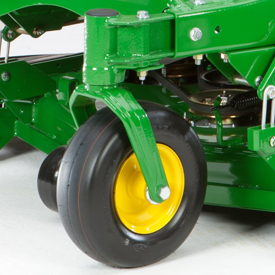 Front caster tire
Front caster tire
The ZTrak E Series Mowers with 48-in. (122-cm) mower decks come with 24x9.5-12 4 PR drive tires. E Series Mowers with 54-in. (137-cm) and 60-in. (152-cm) decks come with 24x12-12 4 PR drive tires. All E Series Mowers are equipped with 13x6.5-6 front pneumatic caster tires for the following:
- Excellent traction, flotation, and curb climbing
- Low center of gravity to increase hillside mowing capability
- Caster wheels and caster wheel towers with sealed bearings for long life and easy steering
- Offset front caster wheels to help improve the inside corner-trim performance and reduce between-blade striping
Michelin, X, and Tweel are trademarks of Michelin North America, Inc.
Powerful 25.0-hp (18.6-kW) commercial-grade engine delivers class-leading performance and efficiency
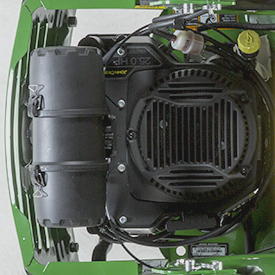 Z915E engine
Z915E engine

The Z915E is powered by an air-cooled, vertical shaft engine:
- 25.0-hp (18.6-kW) gas engine
Engine features include:
- Overhead valve design
- More horsepower and torque per cubic inch of displacement
- Fuel efficient design
- Full-pressure lubrication with full-flow filter
- Reduces engine wear by ensuring proper lubrication, even when operating on hillsides or uneven terrain
- Oil filter helps keep oil clean for increased engine life
- V-twin big block design
- Vertical shaft
- Easy-access, dual-element air filter with quick-release latch
- 15-amp alternator
- Fuel pump
- Complies with strict Environment Protection Agency (EPA) and California Air Resources Board (CARB) emission standards without loss of horsepower or torque
- Aluminum block engines
- Effectively dissipate heat
- Lightweight and strong construction
- Extend engine life due to elimination of debilitating engine temperatures
- Air-cooled engine design
Air cleaner filters out dust that can damage an engine
 Engine air cleaner
Engine air cleaner
 Air cleaner cover removed
Air cleaner cover removed
ZTrak™ Z900 Mowers are equipped with a dual-element, canister-style air filter, easily accessible from the rear of the machine without tools.
- The filtration system pulls clean air from above the engine, in turn filtering out the dust that can damage an engine over time.
- Filters are extremely easy to change when required.
- Pre-cleaner provides more protection against contamination in dusty and dirty applications.
Mow all day on a single tank of fuel with efficient and easy-to-fill fuel tank
 Fuel tank and filler neck
Fuel tank and filler neck
 Fuel filler neck
Fuel filler neck
The ZTrak Z900 Mowers are equipped with one single-fill, top-draw fuel tank:
- 11.5-U.S. gal. (43.5-L) capacity enables operators to mow all day without refueling.
- The fuel gauge makes it quick and easy to see how much fuel is in the tank.
- Top draw provides added safety.
- A large fuel-filler neck is angled to make it easy for an operator to complete the fueling process.
Under normal conditions, load, and operation, fuel consumption for the Z900 ZTrak Mowers is 1.5 U.S. gph (5.7 L/hr) to 2.2 U.S. gph (8.3 L/hr), depending on the horsepower and conditions.
Durable hydrostatic drive train that delivers better cooling and provides easy access
 Heavy-duty ground drive
Heavy-duty ground drive
The hydrostatic drive features two 13-cc (0.8-cu in.) unitized hydraulic pumps combined with commercial-grade, heavy-duty wheel motors into a single unit.
One pump and one motor drive each wheel on the ZTrak™ E and M Series Mowers. This provides several benefits:
- Exceptional cooling in high-load conditions
- Easy-to-check level and refill hydraulic oil
- Opens up access under the seat
Two seat choices with ComfortGlide™ fore/aft suspension offer exceptional operator comfort
There are two seating options available for the E Series, both of which are factory installed:
- Deluxe comfort seat with armrests
- Deluxe comfort seat with armrests and isolation
ComfortGlide fore/aft suspension
 ComfortGlide fore/aft suspension control lever
ComfortGlide fore/aft suspension control lever
Each seat has the ComfortGlide fore/aft suspension system that gives superior ride comfort over uneven areas:
- Seat can travel up to 2 in. (50.8 mm) fore and aft to absorb bumps for a significant enhancement to ride comfort.
- Control lever provides the ability to easily lock out fore/aft suspension movement if desired.
- One lever has three functions:
- Slide seat forward and back 3 in. (10.2 cm) to allow the operator the ability to choose the leg room needed
- Activate ComfortGlide fore/aft seat suspension
- Lock out ComfortGlide fore/aft seat suspension
Deluxe comfort seat with armrests
 Deluxe comfort seat with armrests
Deluxe comfort seat with armrests
The deluxe comfort seat with armrests is standard on all E and M Series models:
- Rubber springs are provided to increase ride comfort.
- A convenient seat latch makes it easy to lift the seat.
- The seat is factory installed.
Deluxe comfort seat with armrests and isolation
 Deluxe comfort seat with armrests and isolation
Deluxe comfort seat with armrests and isolation
 Rubber isolation mount
Rubber isolation mount
The deluxe comfort seat with armrests and isolation is available on the E, M, and R Series:
- Rubber springs are provided to isolate the seat base and to increase ride comfort.
- A convenient seat latch makes it easy to lift the seat.
- Isolation mounting is a good feature to reduce vibration.
- On Z900s ordered with the deluxe comfort seat with armrests and isolation option, it is factory installed.
Designed for operator comfort
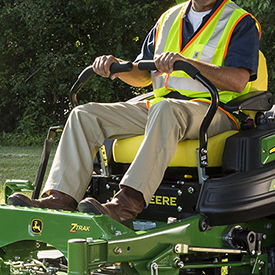 Operator station
Operator station
Two-lever hydrostatic control provides the following:
- The operator can select the ground speed and direction control simply by moving levers forward or reverse.
- Positive neutral lock position for levers provides added safety.
- Brake & Go operator-presence system returns levers to the neutral position when the brake pedal is actively engaged.
- Starting the machines are as easy as starting a car. It no longer matters if the control levers are extended out or pulled in, as long as the parking brake is engaged. Just turn the key and go.
- Wide-bend, large-diameter steering levers swing out easily for entry and exit from the operator platform.
Brake & Go starting system
 Parking brake pedal (Z900R Series)
Parking brake pedal (Z900R Series)
 Parking brake lever (Z900 E and M Series)
Parking brake lever (Z900 E and M Series)
The Brake & Go starting system is a John Deere exclusive. This feature makes the starting process on all ZTrak™ mowers easier, while also making it possible to remove two interlock switches from the machine.
The Brake & Go starting procedure helps a novice operator look and feel like a professional. To start the machine, the parking brake must be engaged. It does not matter whether the power take-off (PTO) switch is on or off, nor does it matter if the control levers are pulled in or in the out position.
As long as the parking brake is engaged, the machine will start. When the parking brake is applied, the control levers cannot be moved to the forward or reverse positions.
Adjustable levers
 Adjustable levers
Adjustable levers
The motion control levers have two height positions and can also be adjusted forward or rearward within the slotted holes. The levers should be adjusted so the operator can achieve a full range of control operation comfortably.
Tracking adjustment
 Tracking adjustment
Tracking adjustment
The easy-to-turn (from-the-seat) tracking adjustment allows operators to keep their mowers straight and produce professional striping results.
Onboard storage and cup holder
 Onboard storage
Onboard storage
 Cup holder
Cup holder
Several storage areas are provided on the ZTrak machines. A convenient cup holder is also available.
Right-hand control panel
 Right-hand control panel
Right-hand control panel
 Right-hand control panel
Right-hand control panel
The controls are grouped together on the right console, providing one central location for key switch, throttle, PTO engagement, height-of-cut, diagnostics, and hour meter.
- Rocker-type PTO switch
- Height-of-cut knob with transport lock
- Key switch
- Hour meter
- Throttle
- Separate choke control
- Easy choke operation yields less fouling of plugs
Easy-to-operate height-of-cut adjustment enables on-the-go changes
 Mower deck height adjustment knob
Mower deck height adjustment knob
An easy-to-use cutting-height lift system allows the operator to adjust the mower deck height with no tools and minimal effort. The easy-to-grip knob allows operators to dial in the desired height of cut (HOC).
Cutting height can be adjusted from approximately 1 in. to 5.5 in. (2.5 cm to 14 cm). Each increment on the knob adjusts the HOC approximately 0.25 in. (0.64 cm). The deck can also be raised and locked in a transport position to provide maximum ground clearance when moving the machine from one area to another.
The transport lock function allows the deck to be returned to the previous HOC after being in the transport position:
- Use the foot-lift pedal to lift the deck and engage the transport lock.
- Rotate the knob to adjust from 1 in. to 5.5 in. (2.5 cm to 14 cm) in 0.25-in. (0.64 cm) increments.
This design increases productivity by allowing operators to change the cutting height without having to leave the seat.
Mower is easy to service with many accessible components
 Z955R EFI left front view
Z955R EFI left front view
The design of the Z900 Series makes many service components reachable and easily accessible from the ground.
- Large, open engine compartment at the rear of the machine provides convenient servicing and ensures the engine heat is directed away from the operator.
 Flip-up foot panel
Flip-up foot panel
 Flip-up seat
Flip-up seat
Onboard maintenance chart
 Maintenance chart
Maintenance chart
All ZTrak™ Mowers come with an onboard maintenance chart that is conveniently located inside the right-hand console. The service interval chart gives necessary service intervals.
Diagnostics
 Hour meter (M Series pictured)
Hour meter (M Series pictured)
 Diagnostic chart
Diagnostic chart
The hour meter shows the number of hours the machine is run when the key switch is in the on position. It only counts the hours the engine is actually running. Machine diagnostics are the first step of a monitoring system to help operators quickly diagnose common downtime issues. A trouble code light is included on the hour meter.
Use of the hour meter and service interval chart helps determine when the machine will need service.
Rollover protective structure (ROPS) enhances operator safety
 ROPS up
ROPS up
 ROPS mid position
ROPS mid position
 ROPS down position
ROPS down position
The ZTrak™ Z900E, M, and R Series Mowers are equipped with a standard two-post folding ROPS and seat belt. The folding ROPS enhances operator safety and provides ample clearance when storing the mower in garages or sheds:
- ISO21299 certification
- Foldable
The ROPS system can be repositioned without the use of tools. Under normal operation, the ROPS should be in the up position. If operating in low clearance areas, they can be folded and secured out of the way. The ROPS can also be pinned halfway down to accommodate machines equipped with a material collection system.
Three-year, bumper-to-bumper warranty
 Z955M ZTrak™ Mower
Z955M ZTrak™ Mower
 Z955R ZTrak Mower
Z955R ZTrak Mower
E and M Series 3-year, 1200-hour bumper-to-bumper warranty
An exclusive 2-year, unlimited hour/3-year, 1200-hour (whichever comes first) bumper-to-bumper warranty is standard for all John Deere E and M Series Mowers. The warranty is best in its class and places John Deere at the forefront of commercial mowing. It is also hassle free, with one company handling all of the paperwork.
NOTE: 36 months or 1200 hours, whichever comes first. For the first 24 months, there is no hour limitation.
R Series 3-year, 1500-hour bumper-to-bumper warranty
An exclusive 2-year, unlimited hour/3-year, 1500-hour (whichever comes first) bumper-to-bumper warranty is standard on all John Deere R Series mowers. The warranty is best in the industry and puts John Deere at the forefront of commercial mowing. It is also hassle free, with one company handling all of the paperwork.
NOTE: 36 months or 1500 hours, whichever comes first. For the first 24 months, there is no hour limitation.
Mower decks are safety certified
 Z950M ZTrak Mower
Z950M ZTrak Mower
Mowers decks are evaluated by the manufacturer (John Deere Turf Care) and conform to American National Standards Institute (ANSI) B71.4 2004 safety certification specifications for commercial turf care equipment.
Durable 7-Iron™ II decks pressed from a single piece of steel
 60-in. (152-cm) mower deck shown on Z915E
60-in. (152-cm) mower deck shown on Z915E
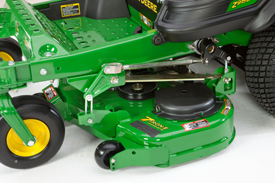 48-in. (122-cm) mower deck shown on Z915E
48-in. (122-cm) mower deck shown on Z915E
The ZTrak™ E Series Mowers are equipped with a side-discharge, 7-Iron II mower deck.
7-Iron II mower decks have demonstrated quality, performance, and durability. They deliver a high quality cut in diverse conditions.
Key features of the 7-Iron II mower deck:
- Deck is stamped from 7-gauge, 0.179-in. (4.6-mm) steel to minimize the number of welds and provide a smooth underside, with fewer sharp corners, for reduced material buildup.
- This design minimizes the number of welds on the deck shell itself.
- There is an anti-skid pad on the top corner of the trim side of the deck.
- High blade tip speed - 18,500 fpm (5,638.8 m/min) for more blade cuts per inch mowed.
- A deep-deck design of 5.5 in. (14 cm) delivers excellent airflow so material can be processed quickly and efficiently.
- The wide and high discharge opening provides even clipping dispersal for an excellent finished appearance in all conditions.
 Mower leading-edge reinforcement
Mower leading-edge reinforcement
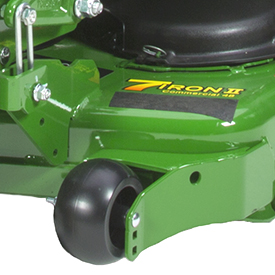 Double captured anti-scalp wheel
Double captured anti-scalp wheel
- Deck has rectangular leading deck edge reinforcement, and the rounded corners of the stamped deck help distribute impact stress to reduce the potential of damage when the mower contacts trees, rocks, curbs, and other fixed obstacles.
- Dual-captured anti-scalp wheels on the front of the deck provide flotation over even the toughest terrain.
- Three 1-in. (2.54-cm) cold-forged spindles are heat-treated for strength without bulk and are supported by ball bearings, providing reliability and performance; spindle housings are ribbed cast aluminum, providing both excellent strength and heat dissipation.
- The front edge is raised above the blade plane to allow even cutting of tall grass and is reinforced with a square bar for durability. The front baffle has been designed to better manage airflow and control clippings.
- Grease fittings on each of the three spindles are accessible from the top.
- Blade overlap is 1.6 in. (40.6 mm) to reduce striping between blades.
- Quick-change cutting-height adjustment is available.
7-Iron II mower deck
The Z915E is available with a choice of mower decks:
- 48 in. (122 cm)
- 54 in. (137 cm)
- 60 in. (152 cm)
The Z915E uses a vertical-shaft engine. The power take-off (PTO) clutch is located on the bottom of the engine with the belt extending from the clutch to the mower deck, which is turned on and off by an electromagnetic clutch.
Spindle assembly provides greater performance and reliability
 Spindle assembly
Spindle assembly
On every John Deere ZTrak™ mower deck, there are three 1-in. (2.5-cm) spindles that are cold-forged and heat-treated for strength without bulk. The spindles are supported by precision ball bearings, providing great performance and reliability.
The spindle housing is made of aircraft-grade, ribbed cast aluminum. This unique casting design embosses reinforcing gussets in the housing, which adds both strength and cooling surface area that stands up to commercial applications.
These spindles can be greased from the top and require no disassembly to reach. Grease channels provide lubrication to both bearings.
Features
Simpler, more productive harvest with less labor
 CS690 Cotton Stripper
CS690 Cotton Stripper
 CS690 Cotton Stripper with round modules
CS690 Cotton Stripper with round modules
The CS690 introduces true nonstop harvesting technology to the cotton stripper for increased productivity. Unlike traditional basket strippers, the CS690 provides its own onboard module building system, thereby eliminating boll buggy drivers, module builder operators, and all the supporting equipment traditionally needed during cotton harvest.
One Floydada, TX grower explained, "(The CS690) gives us an opportunity to reduce our labor, it gives us a more efficient way of handling and storing our cotton, and the non-stop harvest means your efficiencies go way up."
Increased productivity
The nonstop harvesting of cotton is achieved through the use of a high-volume accumulator, round module builder, and round module handler. The accumulator collects cotton while a formed round module is wrapped with a protective film and ejected onto the machine's rear handler. The handler allows a completed round module to be carried to the end of the row.
Since round modules are formed, ejected, and can be off-loaded while the CS690 is still harvesting, the operator can remain on the row instead of unloading or waiting to unload cotton into boll buggies or module builders.
Reduction of labor
It can be difficult acquiring good labor to be able to keep multiple cotton strippers, boll buggies, and module builders up and running. With the CS690, harvesting cotton simply requires one operator per machine, and one tractor operator to stage modules for transport. Additionally, since each round module is wrapped with a protective film, they do not require the application of a module tarp for field storage protection. The CS690 helps reduce the risks associated with finding labor, enabling producers to have more efficient and less labor intensive harvesting operations.
A cotton harvesting veteran in the Ropesville, TX area stated, "The nonstop harvesting is what makes the CS690 what it is. Being able to harvest cotton with one individual doing the same thing that nine or 10 people were doing previously."
Reduction of support equipment
Typically each basket-style stripper requires a fleet of support equipment to achieve maximum harvest productivity:
- Boll buggy
- Boll buggy tractor
- Module builder
- Module builder tractor
- The CS690 requires only two pieces of support equipment:
- Frontier™ CM1100 Cotton Module Handler (or equivalent)
- 8000 Series (or equivalent) Row-Crop Tractor
These two pieces of equipment are used to stage round modules end-to-end in groups of four, so they may be picked up by a module truck. Producers and ginners also have the flexibility to haul the round modules on flatbed trailers, providing the opportunity to haul more pounds per load for reduced transport costs. Since modules can be staged any time, day or night, one tractor and CM1100 Cotton Module Handler can support multiple CS690 Cotton Strippers.
This reduction in support equipment means less equipment and traffic in the field and less fuel consumption. The CS690 not only creates a simplified harvest scheme, it helps reduce frustration that producers face while having to contend with traffic on increasingly busy roads.
More power to harvest in demanding conditions
 CS690
CS690
 CS690 power module
CS690 power module
The CS690 Cotton Stripper is a powerful harvesting system only from John Deere. With a 373-kW (500-hp), John Deere Final Tier 4 (FT4) 13.5L (824-cu in.) PowerTech™ PSS engine, the CS690 packs enough punch to harvest in the most demanding conditions.
 Fuel fill up
Fuel fill up
Many ask how frequently one must stop to fill up the CS690 with diesel fuel and the answer is simple - just once a day. The 61-L (16-gal.) diesel exhaust fluid (DEF) tank will last much longer. The CS690 comes equipped with a 1022-L (270-gal.) fuel tank that allows the operator to fill up the tank while servicing the cotton stripper.
When it is time to move from one field to the next, the CS690 offers a transport configuration with a height of 4765 mm (187.5 in.). It moves from harvest mode to transport mode in roughly one minute and allows the operator to easily move down the road at 27 km/h (17 mph).
Whether trying to beat a rain coming in, harvesting in tough conditions, or simply moving from one field to the next, the CS690 provides power on which operators can depend.
Conserve fiber quality with 360 degrees of protection
 Conventional module
Conventional module
A combination of high winds and rain can damage cotton whether in the field or at gin yards.
 Round module
Round module
The CS690 Cotton Stripper provides weather resilience for harvested cotton only from John Deere. With the fixed, 2.44-m (8-ft) wide round modules, producers and ginners receive 360 degree of protection, creating a unique shape that keeps cotton from blowing away and from wicking moisture that can reduce crop quality.
Modules are wrapped three times within the CS690’s onboard module builder, ensuring cotton fiber and seed protection. Each portion of wrap contains two segments of linear low-density polyethylene (LLDPE) film. A non-tacky layer is followed by two tacky layers to keep the round modules in a uniform shape and provide protection from wind, dust, and rain.
The Z-LOCK® dual tail-adhesive system ensures the tapered end of the wrap is secure in high winds and rain and that the next portion is ready for wrapping the next module.
 Module staging
Module staging
Producers who have round modules on their farms are impressed by the round modules' ability to preserve the cotton fiber and quality. One south Texas coastal producer harvested his entire south Texas cotton crop with 7760 Cotton Pickers. He shared, “The regular modules always have a bale or two on each end that will be a grade difference in color, and they also lose sometimes 10 to 15 percent of the cotton down on the ground. If you have got 25 cm (10 in.) to 30 cm (12 in.) of rain on the regular module, the module trucks just have to shave it off. And that cotton is still sitting out on the gin yard when the ginning is over; it is hard to determine how much we actually lost. In our round modules, we had zero loss this year.”
The CS690 offers that same preservation capability for the cotton stripper producer.
With no lost cotton, this producer was able to harvest his entire crop and have it arrive at the gin feeder floor, ready to be ginned. No other cotton harvesting system available on the market today can deliver a producer's crop from the field to the gin floor.
 Loading round modules
Loading round modules
Producers are not the only ones who see benefits in weather resilience with round modules; ginners are also enjoying the benefits. A ginner in North Carolina with much experience ginning cotton, both round and traditional modules, shared the following observation, “Once the cotton is in these round modules, it is safe. You do not have to worry about weather. You do not have to worry about time. It seems like the longer they stay in there, the better they gin.”
Z-LOCK is a trademark of Tama Plastic Industry.
Ginning advantages offered only by the CS690
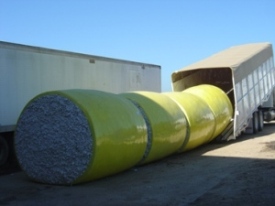 Module truck unloading round modules
Module truck unloading round modules
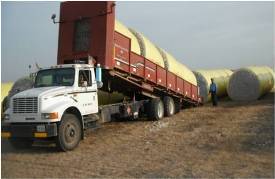 Unloading round modules in gin yard
Unloading round modules in gin yard
The CS690 makes the ginning season easier for one of cotton farmers' most important production partners - ginners.
During the cotton ginning season, ginners are constantly on the go. They coordinate moving modules from fields to the gin yard. They manage the cotton entering the feeder floor and they keep the gin running should something break down. While doing all this, they still manage to gin 218-kg (480-lb) bales of cotton and place them securely in their warehouses, ready to go to a warehouse or mill. Clearly, being a ginner is hard work.
In the middle of the cotton harvest season, module trucks can run 24 hours a day trying to collect cotton modules that sit on turn rows. If rain is on the way, module truck drivers may need to change their scheduled routes and go to fields that could be impassable after a deluge to ensure the cotton makes it to the gin yard. Damaged traditional modules from wind can also quickly change pickup priorities.
Producers who use traditional modules have only one option to get their cotton to the gin - the traditional module truck. However, producers who generate round modules from their CS690 can move round modules with increased flexibility by two methods.
The Frontier™ Round Module Handler allows staging during or after harvest wherever is most convenient or ideal for pick up. After staging, round modules can be moved from the field by standard module trucks (after the inner six chains are changed) or flatbed semi-trailers. Four round modules fit easily in a standard module truck, whereas a 14.6-m (48-ft) flatbed trailer can haul six round modules, and a 16.2-m (53-ft) flatbed trailer can transport seven round modules at a time. Ginners and their module truck drivers can count on increased transportation flexibility when round modules are ginned at their facilities.
 Flatbed trailer with round modules
Flatbed trailer with round modules
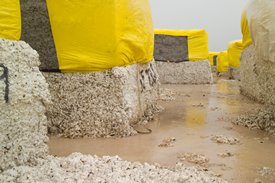 Gin yard (wet modules)
Gin yard (wet modules)
Increased flexibility in moving modules from the field to the gin yard is only the beginning of a long list of benefits ginners gain with round modules. Round modules are fully wrapped, minimizing the amount of lost cotton in the field or at the gin yard. For a gin ginning round modules, there is no need for a cleanup crew since there is no lost cotton on the ground. Conventional modules sitting on the ground have the opportunity to wick water off the ground, whereas the fully-wrapped modules keep cotton dry from the field, to the gin yard, to the gin.
One ginner in a coastal south Texas community had to deal with a very large obstacle during a past cotton harvest: Hurricane Dolly. He recalled, “We had 25 cm (10 in.) to 30 cm (12 in.) of rain across a 10-day period. We ginned round bales in the daytime and the conventional cotton in the evenings. During that period, we measured the amount of gas we were using on both of these, and we had about a 40 percent savings on gas [with the round modules].”
For ginners, that amount of savings can help maintain a gin's profitability. Drier cotton in round modules compared to conventional modules was not a unique occurrence. Gin studies conducted throughout the south found that cotton in round modules received better grades and was significantly drier than that stored in traditionally-shaped modules.
Ginners have reported positive results when ginning round modules. They have found the compact, round module design helps reduce cotton loss and quality degradation. The highly engineered wrap provides weather- and element-resistant round modules that preserve the quality of fiber and seed delivered to the gin.
Overall, ginners are pleased with the consistent module size, shape, and reduced moisture levels that facilitate increased throughput at the gin. In addition, the fully recyclable wrap may be sold to recyclers in the area, an extra income for the gin.
Round module moisture sensing ensures fiber quality
 Moisture sensor
Moisture sensor
The moisture sensor on the CS690 Cotton Harvester provides on-the-go, real-time moisture measurement on which operators can rely. The moisture sensor is mounted on the round module builder which reads cotton moisture levels as the round module is being formed.
Customer value:
- Real-time data to help preserve cotton quality
- Module moisture documented in Harvest Identification, Cotton Pro
- Industry-leading accuracy in the critical 9–13 percent moisture range
Ginning value:
- Maximizes ginning efficiency through module moisture tracking
Theory of operation:
The moisture sensor continuously measures the moisture of seed cotton in contact with the moisture sensor during the round module forming process.
Round module weighing affords expanded capabilities
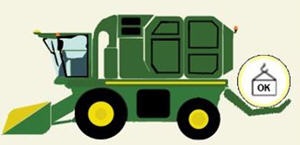 Weighing the module on the handler
Weighing the module on the handler
Round module weighing is standard on all CS690 Cotton Harvesters and provides real-time feedback on module weight during harvest. Operators will appreciate the added capabilities afforded by this system, such as easier yield monitor calibration. Round module weighing teamed with Harvest Identification, Cotton Pro provides the ginner with recorded module weights to be loaded into their system. Gins without scales will be able to use the module weights to provide turnout data to the producer.
Theory of operation:
Round module weighing process starts when the round module ejects from the module builder onto the handler. Once the handle automatically moves to the carry position the module weight is displayed on the CommandCenter™ display and displayed and documented in the GreenStar™ 3 2630 Display or Gen 4 4640 Universal Display if the harvester is equipped with Harvest Identification, Cotton Pro.
Harvest Identification (ID), Cotton Pro tracks round modules from the cab
 Round module information displayed in John Deere Operations Center Field Analyzer
Round module information displayed in John Deere Operations Center Field Analyzer
Harvest Identification, Cotton Pro is the next generation of round module tracking. Features include the documentation of module moisture, weight, editable comments, and other features listed below. Harvest Identification, Cotton Pro links to John Deere Operations Center Field Analyzer tool to visually display module created locations on the yield map along with providing individual module information.
More information about the integration of Harvest Identification, Cotton Pro with John Deere Operations Center is available here.
Operators have multiple options in choosing when to send Harvest Identification, Cotton Pro files from their display to the Operations Center. Choose between the Send Files button on the run page of the display, allowing operators to send files via JDLink™ Connect with Wireless Data Transfer (WDT) and pre-established send times on the setup tab. See below for more detail on these options.
 Send Files button allows operators to share information
Send Files button allows operators to share information
Another option the operator has is to send files automatically at three different times during the day, which are selected by the operator in the Harvest ID, Cotton Pro setup tab.
 Automatically send files via the setup tab
Automatically send files via the setup tab
Harvest Identification, Cotton Pro monitor

Harvest Identification, Cotton Pro incorporates features that allow producers to better manage their cotton harvest data for agronomic decisions. Expanded operational features on the GreenStar 3 2630 or Gen 4 4640 Universal Display include automatic module serial number, module notifications, comments, module history, field file sorting, and season counter reset.
The automatic module serial number feature will fill in a missed module serial number if the radio frequency identification (RFID) tag did not document in the Harvest Identification, Cotton Pro monitor and file. This feature reads the previous module serial number and the serial number of the module after the missed module and automatically completes the missing serial number if it detects sequential serial numbers. In addition to the automatic serial number feature, the serial number field on the display is editable, allowing the operator to add a serial number manually.
Module notifications alert the operator of missing RFID data and potential data loss so the information can be captured and documented while the module is displayed on the GreenStar 3 2630 or Gen 4 4640 Universal Display. This feature allows the information coming from the harvester to John Deere Operations Center to be complete removing the need to correct data later.
Operators have the ability to add comments to modules in the GreenStar 3 2630 or Gen 4 4640 Universal Display while harvesting. This capability allows the producer to manage modules that have a comment and can be used to alert ginners of something specific to the module.
Harvest Identification, Cotton Pro allows operators to view three modules on the GreenStar 3 2630 or Gen 4 4640 Universal Display at one time. This flexibility allows the operator to make comments and compare module information while harvesting in the field.
Producers have the flexibility of creating specific Harvest Identification, Cotton Pro files to meet their needs. A producer can create any one or multiples of the following files: master data file (standard), client data file, field data file, producer ID data file, and gin ID data file. These files allow a producer to manage data for custom harvest producers, by the field, by producer ID, and/or by gin ID. These files shorten the time a producer spends reviewing data.
Harvest Identification, Cotton Pro theory of operation
The backbone of John Deere Harvest Identification, Cotton Pro is the RFID tag chip found in each portion of Tama RMW™ cotton wrap. This module wrap is currently produced with Impinj® Monza® RFID tag chips embedded in the polyurethane material.
These RFID tag chips give each round module the ability to be recorded and processed as single entities. With this unique characteristic, producers and ginners can generate more specific reports, which could define and link attributes to a production area.
Advantages of linking crop characteristics to a production area:
- Ability to see exactly what crop quality a particular section of the field produced
- Finely adjust application rates or even trace back high leaf grades to defoliation problems
Producers need this type of information to more precisely select varieties with characteristics that would allow them to gain the most value out of their land. Harvest Identification, Cotton Pro is the building block to these ideas.
The information found in the Harvest Identification file includes data relevant to both a producer’s documentation requirements and their ginner’s record keeping system. Data files can be transferred from the machine automatically with Wireless Data Transfer (WDT) included in a JDLink Connect subscription or manually using a USB stick. The chart shows what is automatically entered into Harvest Identification, Cotton Pro and what information is populated through operator input, given that a StarFire™ receiver is installed.
John Deere Harvest Identification, Cotton Pro file inputs |
|
Automatically populated fields |
Operator populated fields |
| Module identification number | Client* |
| Module serial number | Farm* |
| Module created Latitude | Field* |
| Module created Longitude | Variety* |
| GMT date | Operator |
| GMT time | Gin ID |
| Machine serial number | Producer ID |
| Local time | |
| Field area | |
| Season total | |
| Module diameter | |
| Module moisture | |
| Module weight | |
| Module drop latitude | |
| Module drop longitude | |
| Field total | |
| Incremental area | |
| Local date | |
| Comments | |
*Fields will be populated automatically if information is preloaded into the display before season and Field Locator is selected.
Module identification (ID) number
The module ID number is used to uniquely identify one module from another. By giving each round module a unique ID number, every module produced has its own description and attributes associated to it. This provides value chain partners the ability to dig deeper into the why and how as it pertains to the production cycle and its effect on quality and output.
Module serial number
The module serial number (SN) is used to give a historical account for each portion of the Tama RMW. This number is used to identify each portion’s year of production, manufacturing location, and production machine.
Module moisture
Individual module moisture is documented for traceability to the producer and ginner. Module moisture is closely tied to cotton quality which helps the producer know when to start and stop harvesting during their harvest day. Ginners can prioritize ginning for modules with high moisture to preserve both fiber and seed quality.
Module weight
Producers can track individual module weights which eases infield yield monitor calibration. Ginners will appreciate the individual weights for their records, specifically gins without scales.
Incremental area
Incremental area provides the producer measured area between round modules. This area provides increments in the field that can be used to identify opportunities in a particular production zone within the field.
Comments
Harvest Identification, Cotton Pro offers producers the capability to add notes to each individual module from the display. This field displays any comments the operator adds while harvesting which can be used by the producer or ginner to track specific modules if needed.
Module created latitude and longitude
These fields provide coordinates on where the module was created, module wrapped, in the machines round module chamber. These two positions help producers identify and/or highlight particular production zones within their operation.
Module drop latitude and longitude
These fields provide coordinates on where the module was dropped in the field to better coordinate module staging activities.
GMT date and time
The GMT time and date was chosen as a global input to represent date and time of module formation.
From the producer’s standpoint
John Deere Harvest Identification, Cotton Pro provides the ability to track and record module formation as it occurs in the field. When a module is unloaded from the machine’s round module chamber, its information is sent to a controller by a specifically designed RFID reader. Here the data is compiled with the operator’s production inputs giving the module its unique identity. With this information, producers can isolate round cotton modules based on fields or specific production areas. Once defined, location coordinates can be used to correlate applied inputs to yield performance. Producers do not have this degree of traceability with traditional basket systems, as multiple machines could be feeding one module builder; mixing cotton from multiple field sites into large traditional modules. It is almost impossible to look at characteristics on a per acre basis this way.
Cotton producers have asked for another way to track and tag modules without having to manually go to each individually in the field. Harvest Identification, Cotton Pro gives producers a unique and efficient way to record information from modules one-fourth the size of traditional modules, and it is all done from the machine’s operator seat. Also, with Harvest Identification, Cotton Pro, a producer does not have to wonder how many modules were made in each field. The machine collects that information while also connecting module identification numbers to producer defined inputs; populating a data file that not only can be used for yearly production records but can also be sent to gins as a harvest report.
From the ginner’s standpoint
John Deere Harvest Identification, Cotton Pro provides an avenue for a more robust module tracking and logistical system. By incorporating Harvest Identification, Cotton Pro into the ginning process and utilizing an electronic booking system, organizations will see efficiency increases throughout their operation. From the way production information is entered on the producer side to how gin managers initiate module transport; ginners will see a dramatic improvement in their day-to-day operation.
One part of the system is the actual Harvest Identification file that is sent from the producer to the gin. The other important piece is the RFID tag found in the wrap portions. RFID is a leading technology in inventory tracking/verification, as it provides the ability to record real-time activity and product movement. As a wireless non-contact use of radio-frequency electromagnetic fields, any object with an RFID tag chip has the ability to be recorded using RFID readers and antennas.
Like most businesses, cotton gins have product that is constantly moving from one place to another.
RFID technology is starting to take the place of the common barcode system as a more efficient and user-friendly way to track inventory. One of the biggest advantages of RFID tracking is the ability to read tags that are not within a line-of-sight or that may be imbedded within an object. When trying to implement an RFID system, the user needs three basic parts: a tag chip, reader hardware, and the supporting software to translate data into a useable format.
From the simple advantage of recording modules as they are made to gins building robust RFID-based tracking systems, the need to know more is beginning to show itself in the cotton industry.
Impinj and Monza are trademarks of Impinj, Inc. Tama RMW is a trademark of Tama Plastic Industry.
Features
Simpler, more productive harvest with less labor
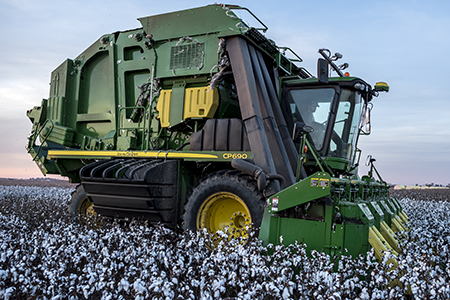 CP690 Cotton Picker
CP690 Cotton Picker
 CP690 round modules
CP690 round modules
The CP690 continues the legacy of exclusive non-stop harvesting technology for increased productivity. Unlike traditional basket pickers, the CP690 provides its own onboard module building system, eliminating boll buggy drivers, module builder operators, and all the supporting equipment traditionally needed during cotton harvest.
Operators who harvest cotton with the CP690 enjoy the fact they never have to wait in the field. A cotton harvesting veteran in the Louisiana Delta said, "Driving a standard basket picker when you are in good cotton, which is the time you really want to move faster, you have to wait on a boll buggy. The operator has to travel all the way back to the module builder, dump that load, and then try to find you again. That whole time you are sitting in the field doing nothing. You are not productive. With the onboard module builder, you are constantly productive. You never have to stop. You keep going and going, and this saves you so much time throughout the day."
Increased productivity
The nonstop harvesting of cotton is achieved through the use of a high-volume accumulator, round module builder, and round module handler. The accumulator collects cotton while a formed round module is wrapped with a protective film and ejected onto the machine's rear handler. The handler allows a completed round module to be carried to the end of the row.
Since round modules are formed, ejected, and can be off-loaded while the CP690 is still harvesting, the operator can remain on the row instead of unloading or waiting to unload cotton into boll buggies or module builders.
Reduction of labor
It can be difficult acquiring good labor to be able to keep multiple cotton pickers, boll buggies, and module builders up and running. With the CP690, harvesting cotton simply requires one operator per machine and one tractor operator to stage modules for transport. Additionally, since each round module is wrapped with a protective film, they do not require the application of a module tarp for field storage protection. The CP690 helps reduce the risks associated with finding labor, enabling producers to have more efficient and less labor-intensive harvesting operations.
One producer was excited about the labor savings the on-board round module building system would bring to his operation. He was able to take his existing picking fleet down from six machines to four machines and significantly reduce the support staff that goes along with them. With a traditional fleet, he was running 22 to 24 people on any given day, but could likely reduce that number to about seven.
Reduction of support equipment
Typically each basket-style picker requires a fleet of support equipment to achieve maximum harvest productivity:
- Boll buggy
- Boll buggy tractor
- Module builder
- Module builder tractor
The CP690 requires only two pieces of support equipment:
- Frontier™ CM1100 Cotton Module Handler (or equivalent)
- 8R Series (or equivalent) Row-Crop Tractor
These two pieces of equipment are used to stage round modules end-to-end in groups of four, so they may be picked up by a module truck. Producers and ginners also have the flexibility to haul the round modules on flatbed trailers, providing the opportunity to haul more pounds per load for reduced transport costs. Since modules can be staged any time, day or night, one tractor and CM1100 Cotton Module Handler can support multiple CP690 Cotton Pickers.
This reduction in support equipment means less equipment and traffic in the field and less fuel consumption. The CP690 not only creates a simplified harvest scheme, it helps reduce frustration that producers face while having to contend with traffic on increasingly busy roads.
More power to pick in demanding conditions
 CP690 harvesting
CP690 harvesting
The CP690 Cotton Picker is a powerful harvesting system - only from John Deere.
With a 418-kW (560-hp), 13.5L (824-cu in.) John Deere PowerTech™ PSS Final Tier 4 (FT4) engine, the CP690 packs enough punch to pick in the most demanding conditions. An additional 22.4-kW (30-hp) of boost is generated from the turbocharger for even greater output when needed. A conventional basket picker can spend 20 percent or more of its time unloading, waiting for boll buggies, or driving back and forth to a module builder. The CP690’s nonstop harvesting system keeps operators where they need to be — in the field, picking cotton.
Producers have been greatly impressed with the engine's power, as well as the added benefit of having the full-time four-wheel drive (4WD) and anti-slip regulation on the CP690. These standard features enable them to harvest while other crews are waiting for the ground to dry.
 Fuel fill-up
Fuel fill-up

Many ask how frequently one must stop to fill up the CP690 with diesel fuel and the answer is simple: just once a day. Additionally, the 61-L (16-gal.) diesel exhaust fluid (DEF) tank will last much longer. The CP690 comes equipped with a 1401-L (370-gal.) fuel tank that allows the operator to fill up the tank while servicing the picker.
When it is time to move from one field to the next, the CP690 offers a transport configuration with a height of 4.4 m (14.3 ft). It moves from harvest mode to transport mode in roughly one minute and allows the operator to easily move down the road at 27 km/h (17 mph).
Whether trying to beat a rain coming in, harvesting in tough muddy conditions, or simply moving from one field to the next, the CP690 provides power on which operators can depend.
Conserve fiber quality with 360 degrees of protection
 Conventional module
Conventional module
A combination of high winds and rain can damage cotton whether in the field or at gin yards.
 Round module
Round module
With the fixed, 2.44-m (8-ft) wide round modules, producers and ginners receive 360 degrees of protection, creating a unique shape that keeps cotton from wicking moisture that can reduce crop quality.
Modules are wrapped three times within the CP690's onboard module builder, ensuring cotton fiber and seed protection. Each portion of wrap contains two segments of linear low-density polyethylene (LLDPE) film. A non-tacky layer is followed by two tacky layers to keep the round modules in a uniform shape and provide protection from dust and rain.
The Z-LOCK® with dual tail adhesive system ensures the tapered end of the wrap is secure in high winds and rain.
 Module staging
Module staging
Producers have been impressed by the round modules' ability to preserve the cotton fiber and quality. One south Texas coastal producer harvested his entire south Texas cotton crop with an on-board module building picker. He shared, "The regular modules always have a bale or two on each end that will be a grade difference in color, and they also lose sometimes 10 to 15 percent of the cotton down on the ground. If you have got 25 cm (10 in.) to 30 cm (12 in.) of rain on the regular module, the module trucks just have to shave it off. And that cotton is still sitting out on the gin yard when the ginning is over; it's hard to determine how much we actually lost. In our round modules, we had zero loss this year."
With no lost cotton, this producer was able to harvest his entire crop and have it arrive at the gin feeder floor, ready to be ginned. No other cotton harvesting system available on the market today can deliver all of a producer's crop from the field to the gin floor.
 Loading round modules
Loading round modules
Producers are not the only ones who see benefits in weather resilience with round modules; ginners are also enjoying the benefits. A veteran ginner in North Carolina, with much experience ginning, both round and traditional modules, shared the following observation, "Once the cotton is in these round modules, it is safe. You do not have to worry about weather. You do not have to worry about time. It seems like the longer they stay in there, the better they gin."
Z-LOCK is a trademark of Tama Plastic Industry.
Ginning advantages offered only by John Deere
 Module truck loading round modules
Module truck loading round modules
 Unloading round modules in gin yard
Unloading round modules in gin yard
The CP690 Cotton Picker brings advantages to one of the cotton producer’s most important production partners - their ginners.
During the cotton ginning season, ginners are constantly on the go. They coordinate moving modules from fields to the gin yard. They manage the cotton entering the feeder floor and keep the gin running should something break down. While doing all this, they still manage to gin and package 218-kg (480-lb) bales of cotton that are ready to go to a warehouse and ultimately a mill.
In the middle of the cotton harvest season, module trucks can run 24 hours a day trying to collect cotton modules that sit on turn rows. If rain is on the way, module truck drivers may need to change their scheduled routes and go to fields that could be impassable after a deluge to ensure the cotton makes it to the gin yard.
Producers who use traditional modules have only one option to get their cotton to the gin: the traditional module truck. However, producers who generate round modules from their CP690 can move round modules with increased flexibility and multiple methods.
The Frontier™ Round Module Handler allows staging during or after harvest wherever is most convenient or ideal for pickup. After staging, round modules can be moved from the field by standard module trucks (after the inner six chains are changed) or flatbed semi-trailers. Four round modules fit easily in a standard module truck, whereas a 14.6-m (48-ft) flatbed trailer can haul six round modules, and a 16.2-m (53-ft) flatbed trailer can transport seven round modules at a time.
Ginners need not be concerned their module trucks will not be moving as much cotton with four round modules compared to one conventional module. When comparing truck weights at gins, there were no significant differences in the load sizes drivers delivered from the field. Ginners and their module truck drivers can count on increased transportation flexibility when round modules are ginned at their facility.
 Flatbed trailer with round modules
Flatbed trailer with round modules
 Gin yard (wet conventional modules)
Gin yard (wet conventional modules)
Increased flexibility in moving modules from the field to the gin yard is only the beginning of a long list of benefits ginners gain with round modules. Round modules are fully wrapped, minimizing the amount of lost cotton in the field or at the gin yard. For a gin ginning round modules, there is no need for a cleanup crew since there is no lost cotton on the ground. Conventional modules sitting on the ground can wick water off the ground, whereas the fully-wrapped modules keep cotton dry from the field, to the gin yard, to the gin.
One ginner in a coastal south Texas community had to deal with a very large obstacle during a past cotton harvest: Hurricane Dolly. He recalled, "We had 25 cm (10 in.) to 30 cm (12 in.) of rain across a 10-day period. We ginned round bales in the daytime and the conventional cotton in the evenings. During that period, we measured the amount of gas we were using on both of these, and we had about a 40 percent savings on gas [with the round modules]."
For ginners, that amount of savings can help maintain a gin's profitability. Drier cotton in round modules compared to conventional modules was not a unique occurrence. Gin studies conducted throughout the southern U.S. found that cotton in round modules received better grades and was significantly drier than that stored in traditionally-shaped modules.
Ginners have reported positive results when ginning round modules. They have found the compact, round module design helps reduce cotton loss and quality degradation. The highly engineered wrap provides weather- and element-resistant round modules that preserve the quality of fiber and seed delivered to the gin.
Overall, ginners are pleased with the consistent module size, shape, and reduced moisture levels that facilitate increased throughput at the gin. In addition, the fully recyclable wrap may be sold to recyclers in the area, an extra income for the gin.
Round module moisture sensing ensures fiber quality
 Moisture sensor
Moisture sensor
The moisture sensor on the CP690 Cotton Harvester provides on-the-go, real-time moisture measurement on which operators can rely. The moisture sensor is mounted on the round module builder which reads cotton moisture levels as the round module is being formed.
Customer value:
- Real-time data to help preserve cotton quality
- Module moisture documented in Harvest Identification, Cotton Pro
- Industry-leading accuracy in the critical 9 to 13 percent moisture range
Ginning value:
- Maximizes ginning efficiency through module moisture tracking
Theory of operation:
The moisture sensor continuously measures the moisture of seed cotton in contact with the moisture sensor during the round module forming process.
Round module weighing affords expanded capabilities

Round module weighing is standard on all CP690 Cotton Harvesters and provides real-time feedback on module weight during harvest. Operators will appreciate the added capabilities afforded by this system, such as easier yield monitor calibration. Round module weighing teamed with Harvest Identification, Cotton Pro provides the ginner with recorded module weights to be loaded into their system. Gins without scales will be able to use the module weights to provide turnout data to the producer.
Theory of operation:
Round module weighing process starts when the round module ejects from the module builder onto the handler. Once the handle automatically moves to the carry position the module weight is displayed on the CommandCenter™ display and documented in the GreenStar™ 3 2630 or Gen 4 4640 Universal Display if the harvester is equipped with Harvest Identification, Cotton Pro.
Harvest Identification (ID), Cotton Pro tracks round modules from the cab
 Round module information displayed in John Deere Operations Center Field Analyzer
Round module information displayed in John Deere Operations Center Field Analyzer
Harvest Identification, Cotton Pro is the next generation of round module tracking. Features include the documentation of module moisture, weight, editable comments, and other features listed below. Harvest Identification, Cotton Pro links to John Deere Operations Center Field Analyzer tool to visually display module created locations on the yield map along with providing individual module information.
More information about the integration of Harvest Identification, Cotton Pro with John Deere Operations Center is available here.
Operators have multiple options in choosing when to send Harvest Identification, Cotton Pro files from their display to the Operations Center. Choose between the Send Files button on the run page of the display, allowing operators to send files via JDLink™ Connect with Wireless Data Transfer (WDT) and pre-established send times on the setup tab. See below for more detail on these options.
 Send Files button allows operators to share information
Send Files button allows operators to share information
Another option the operator has is to send files automatically at three different times during the day, which are selected by the operator in the Harvest ID, Cotton Pro setup tab.
 Automatically send files via the setup tab
Automatically send files via the setup tab
Harvest Identification, Cotton Pro monitor

Harvest Identification, Cotton Pro incorporates features that allow producers to better manage their cotton harvest data for agronomic decisions. Expanded operational features on the GreenStar 3 2630 or Gen 4 4640 Universal Display include automatic module serial number, module notifications, comments, module history, field file sorting, and season counter reset.
The automatic module serial number feature will fill in a missed module serial number if the radio frequency identification (RFID) tag did not document in the Harvest Identification, Cotton Pro monitor and file. This feature reads the previous module serial number and the serial number of the module after the missed module and automatically completes the missing serial number if it detects sequential serial numbers. In addition to the automatic serial number feature, the serial number field on the display is editable, allowing the operator to add a serial number manually.
Module notifications alert the operator of missing RFID data and potential data loss so the information can be captured and documented while the module is displayed on the GreenStar 3 2630 or Gen 4 4640 Universal Display. This feature allows the information coming from the harvester to John Deere Operations Center to be complete removing the need to correct data later.
Operators have the ability to add comments to modules in the GreenStar 3 2630 or Gen 4 4640 Universal Display while harvesting. This capability allows the producer to manage modules that have a comment and can be used to alert ginners of something specific to the module.
Harvest Identification, Cotton Pro allows operators to view three modules on the GreenStar 3 2630 or Gen 4 4640 Universal Display at one time. This flexibility allows the operator to make comments and compare module information while harvesting in the field.
Producers have the flexibility of creating specific Harvest Identification, Cotton Pro files to meet their needs. A producer can create any one or multiples of the following files: master data file (standard), client data file, field data file, producer ID data file, and gin ID data file. These files allow a producer to manage data for custom harvest producers, by the field, by producer ID, and/or by gin ID. These files shorten the time a producer spends reviewing data.
Harvest Identification, Cotton Pro theory of operation
The backbone of John Deere Harvest Identification, Cotton Pro is the RFID tag chip found in each portion of Tama RMW™ cotton wrap. This module wrap is currently produced with Impinj® Monza® RFID tag chips embedded in the polyurethane material.
These RFID tag chips give each round module the ability to be recorded and processed as single entities. With this unique characteristic, producers and ginners can generate more specific reports, which could define and link attributes to a production area.
Advantages of linking crop characteristics to a production area:
- Ability to see exactly what crop quality a particular section of the field produced
- Finely adjust application rates or even trace back high leaf grades to defoliation problems
Producers need this type of information to more precisely select varieties with characteristics that would allow them to gain the most value out of their land. Harvest Identification, Cotton Pro is the building block to these ideas.
The information found in the Harvest Identification file includes data relevant to both a producer’s documentation requirements and their ginner’s record keeping system. Data files can be transferred from the machine automatically with Wireless Data Transfer (WDT) included in a JDLink Connect subscription or manually using a USB stick. The chart shows what is automatically entered into Harvest Identification, Cotton Pro and what information is populated through operator input, given that a StarFire™ receiver is installed.
John Deere Harvest Identification, Cotton Pro file inputs |
|
Automatically populated fields |
Operator populated fields |
| Module identification number | Client* |
| Module serial number | Farm* |
| Module created Latitude | Field* |
| Module created Longitude | Variety* |
| GMT date | Operator |
| GMT time | Gin ID |
| Machine serial number | Producer ID |
| Local time | |
| Field area | |
| Season total | |
| Module diameter | |
| Module moisture | |
| Module weight | |
| Module drop latitude | |
| Module drop longitude | |
| Field total | |
| Incremental area | |
| Local date | |
| Comments | |
*Fields will be populated automatically if information is preloaded into the display before season and Field Locator is selected.
Module identification (ID) number
The module ID number is used to uniquely identify one module from another. By giving each round module a unique ID number, every module produced has its own description and attributes associated to it. This provides value chain partners the ability to dig deeper into the why and how as it pertains to the production cycle and its effect on quality and output.
Module serial number
The module serial number (SN) is used to give a historical account for each portion of the Tama RMW. This number is used to identify each portion’s year of production, manufacturing location, and production machine.
Module moisture
Individual module moisture is documented for traceability to the producer and ginner. Module moisture is closely tied to cotton quality which helps the producer know when to start and stop harvesting during their harvest day. Ginners can prioritize ginning for modules with high moisture to preserve both fiber and seed quality.
Module weight
Producers can track individual module weights which eases infield yield monitor calibration. Ginners will appreciate the individual weights for their records, specifically gins without scales.
Incremental area
Incremental area provides the producer measured area between round modules. This area provides increments in the field that can be used to identify opportunities in a particular production zone within the field.
Comments
Harvest Identification, Cotton Pro offers producers the capability to add notes to each individual module from the display. This field displays any comments the operator adds while harvesting which can be used by the producer or ginner to track specific modules if needed.
Module created latitude and longitude
These fields provide coordinates on where the module was created, module wrapped, in the machines round module chamber. These two positions help producers identify and/or highlight particular production zones within their operation.
Module drop latitude and longitude
These fields provide coordinates on where the module was dropped in the field to better coordinate module staging activities.
GMT date and time
The GMT time and date was chosen as a global input to represent date and time of module formation.
From the producer’s standpoint
John Deere Harvest Identification, Cotton Pro provides the ability to track and record module formation as it occurs in the field. When a module is unloaded from the machine’s round module chamber, its information is sent to a controller by a specifically designed RFID reader. Here the data is compiled with the operator’s production inputs giving the module its unique identity. With this information, producers can isolate round cotton modules based on fields or specific production areas. Once defined, location coordinates can be used to correlate applied inputs to yield performance. Producers do not have this degree of traceability with traditional basket systems, as multiple machines could be feeding one module builder; mixing cotton from multiple field sites into large traditional modules. It is almost impossible to look at characteristics on a per acre basis this way.
Cotton producers have asked for another way to track and tag modules without having to manually go to each individually in the field. Harvest Identification, Cotton Pro gives producers a unique and efficient way to record information from modules one-fourth the size of traditional modules, and it is all done from the machine’s operator seat. Also, with Harvest Identification, Cotton Pro, a producer does not have to wonder how many modules were made in each field. The machine collects that information while also connecting module identification numbers to producer defined inputs; populating a data file that not only can be used for yearly production records but can also be sent to gins as a harvest report.
From the ginner’s standpoint
John Deere Harvest Identification, Cotton Pro provides an avenue for a more robust module tracking and logistical system. By incorporating Harvest Identification, Cotton Pro into the ginning process and utilizing an electronic booking system, organizations will see efficiency increases throughout their operation. From the way production information is entered on the producer side to how gin managers initiate module transport; ginners will see a dramatic improvement in their day-to-day operation.
One part of the system is the actual Harvest Identification file that is sent from the producer to the gin. The other important piece is the RFID tag found in the wrap portions. RFID is a leading technology in inventory tracking/verification, as it provides the ability to record real-time activity and product movement. As a wireless non-contact use of radio-frequency electromagnetic fields, any object with an RFID tag chip has the ability to be recorded using RFID readers and antennas.
Like most businesses, cotton gins have product that is constantly moving from one place to another.
RFID technology is starting to take the place of the common barcode system as a more efficient and user-friendly way to track inventory. One of the biggest advantages of RFID tracking is the ability to read tags that are not within a line-of-sight or that may be imbedded within an object. When trying to implement an RFID system, the user needs three basic parts: a tag chip, reader hardware, and the supporting software to translate data into a useable format.
From the simple advantage of recording modules as they are made to gins building robust RFID-based tracking systems, the need to know more is beginning to show itself in the cotton industry.
Impinj and Monza are trademarks of Impinj, Inc. Tama RMW is a trademark of Tama Plastic Industry.
Features
HydraFlex™ float system improves operator control
The HydraFlex system hydraulically controls the float of the cutterbar by a simple turn of a knob in the cab. This provides exceptional cutterbar flexibility throughout the entire working pressure range. Higher ground speeds can be accomplished with HydraFlex, compared to the conventional float systems.
Feature benefit:
- Float arms, with hydraulic cylinders at every other channel, have replaced the mechanical linkage. These cylinders provide the cutterbar with the ability to float over uneven ground conditions with improved operator control.
- The platform HydraFlex system with an accumulator maintains a constant ground pressure over changing ground conditions. Manual mode is for locking out the cutterbar in the rigid mode.
 Float arms
Float arms
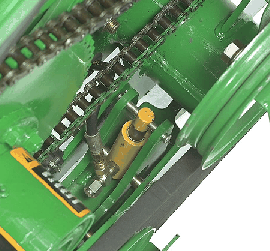 Hydraulic cylinders at every channel
Hydraulic cylinders at every channel
Functionality
In automatic mode, the operator sets a desired cutterbar ground pressure, and the system will maintain this setting. If a different set point is desired, the operator adjusts the encoder on the armrest board, and an updated cutterbar float pressure reading will be shown on the cornerpost display. For increased ground following in uneven terrain, decrease cutterbar pressure to make the cutterbar heavy to the ground. If soil pushing occurs, increase the cutterbar pressure to make the cutterbar lighter to the ground.
Epicyclic knife drive increases drive capacity
The heavy-duty epicyclic knife drive gearbox provides an enhanced knife-drive system that increases drive capacity with less vibration and improved reliability.
Feature benefit:
- Provides high level of reliability and durability
- Minimizes vibration
- Fast, efficient cutting action for higher harvesting speeds
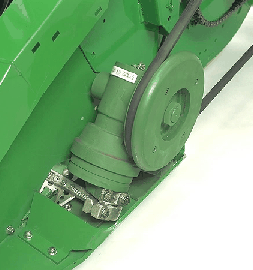 Epicyclic knife-drive gearbox
Epicyclic knife-drive gearbox
Functionality:
- 89-mm (3.5-in.) knife stroke adds a more efficient cutting action. The increased stroke improves the cutterbar's ability to cut even in adverse conditions, such as large-stemmed crops or weeds, without plugging.
- Knife speed is 520 rpm.
- Reliability is improved with an in-line versus wobble-geometry knife head, which oscillates in a straight line and not through a radius like the previous knife drive.
- Knife head and gearbox attachment are improved. Two cap screws can be easily removed if any service to the knife is required.
Enhanced single-point latching system is fast and easy
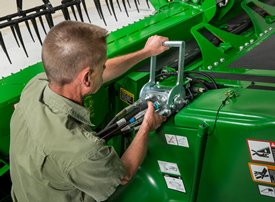 Enhanced single-point latching system
Enhanced single-point latching system
John Deere’s single-point header latching system provides combine operators a fast and easy method for connecting all front-end equipment. One easy motion of the lever connects the electrical and hydraulic circuits along with header retaining pins.
Feature benefit:
- Reduces the time required to change over headers.
- No tools required to remove headers for transport or storage.
Functionality:
The enhanced single-point latching system, includes a valve assembly mounted to all platform and corn head back sheets. These assemblies include an orifice valve unique to the header type and a pressure override valve. Together, these valves ensure the performance and reliability of header hydraulic functions.
Features
HydraFlex™ float system improves operator control
The HydraFlex system hydraulically controls the float of the cutterbar by a simple turn of a knob in the cab. This provides exceptional cutterbar flexibility throughout the entire working pressure range. Higher ground speeds can be accomplished with HydraFlex, compared to the conventional float systems.
Feature benefit:
- Float arms, with hydraulic cylinders at every other channel, have replaced the mechanical linkage. These cylinders provide the cutterbar with the ability to float over uneven ground conditions with improved operator control.
- The platform HydraFlex system with an accumulator maintains a constant ground pressure over changing ground conditions. Manual mode is for locking out the cutterbar in the rigid mode.
 Float arms
Float arms
 Hydraulic cylinders at every channel
Hydraulic cylinders at every channel
Functionality
In automatic mode, the operator sets a desired cutterbar ground pressure, and the system will maintain this setting. If a different set point is desired, the operator adjusts the encoder on the armrest board, and an updated cutterbar float pressure reading will be shown on the cornerpost display. For increased ground following in uneven terrain, decrease cutterbar pressure to make the cutterbar heavy to the ground. If soil pushing occurs, increase the cutterbar pressure to make the cutterbar lighter to the ground.
Epicyclic knife drive increases drive capacity
The heavy-duty epicyclic knife drive gearbox provides an enhanced knife-drive system that increases drive capacity with less vibration and improved reliability.
Feature benefit:
- Provides high level of reliability and durability
- Minimizes vibration
- Fast, efficient cutting action for higher harvesting speeds
 Epicyclic knife-drive gearbox
Epicyclic knife-drive gearbox
Functionality:
- 89-mm (3.5-in.) knife stroke adds a more efficient cutting action. The increased stroke improves the cutterbar's ability to cut even in adverse conditions, such as large-stemmed crops or weeds, without plugging.
- Knife speed is 520 rpm.
- Reliability is improved with an in-line versus wobble-geometry knife head, which oscillates in a straight line and not through a radius like the previous knife drive.
- Knife head and gearbox attachment are improved. Two cap screws can be easily removed if any service to the knife is required.
Enhanced single-point latching system is fast and easy
 Enhanced single-point latching system
Enhanced single-point latching system
John Deere’s single-point header latching system provides combine operators a fast and easy method for connecting all front-end equipment. One easy motion of the lever connects the electrical and hydraulic circuits along with header retaining pins.
Feature benefit:
- Reduces the time required to change over headers.
- No tools required to remove headers for transport or storage.
Functionality:
The enhanced single-point latching system, includes a valve assembly mounted to all platform and corn head back sheets. These assemblies include an orifice valve unique to the header type and a pressure override valve. Together, these valves ensure the performance and reliability of header hydraulic functions.
Features
HydraFlex™ float system improves operator control
The HydraFlex system hydraulically controls the float of the cutterbar by a simple turn of a knob in the cab. This provides exceptional cutterbar flexibility throughout the entire working pressure range. Higher ground speeds can be accomplished with HydraFlex, compared to the conventional float systems.
Feature benefit:
- Float arms, with hydraulic cylinders at every other channel, have replaced the mechanical linkage. These cylinders provide the cutterbar with the ability to float over uneven ground conditions with improved operator control.
- The platform HydraFlex system with an accumulator maintains a constant ground pressure over changing ground conditions. Manual mode is for locking out the cutterbar in the rigid mode.
 Float arms
Float arms
 Hydraulic cylinders at every channel
Hydraulic cylinders at every channel
Functionality
In automatic mode, the operator sets a desired cutterbar ground pressure, and the system will maintain this setting. If a different set point is desired, the operator adjusts the encoder on the armrest board, and an updated cutterbar float pressure reading will be shown on the cornerpost display. For increased ground following in uneven terrain, decrease cutterbar pressure to make the cutterbar heavy to the ground. If soil pushing occurs, increase the cutterbar pressure to make the cutterbar lighter to the ground.
Epicyclic knife drive increases drive capacity
The heavy-duty epicyclic knife drive gearbox provides an enhanced knife-drive system that increases drive capacity with less vibration and improved reliability.
Feature benefit:
- Provides high level of reliability and durability
- Minimizes vibration
- Fast, efficient cutting action for higher harvesting speeds
 Epicyclic knife-drive gearbox
Epicyclic knife-drive gearbox
Functionality:
- 89-mm (3.5-in.) knife stroke adds a more efficient cutting action. The increased stroke improves the cutterbar's ability to cut even in adverse conditions, such as large-stemmed crops or weeds, without plugging.
- Knife speed is 520 rpm.
- Reliability is improved with an in-line versus wobble-geometry knife head, which oscillates in a straight line and not through a radius like the previous knife drive.
- Knife head and gearbox attachment are improved. Two cap screws can be easily removed if any service to the knife is required.
Enhanced single-point latching system is fast and easy
 Enhanced single-point latching system
Enhanced single-point latching system
John Deere’s single-point header latching system provides combine operators a fast and easy method for connecting all front-end equipment. One easy motion of the lever connects the electrical and hydraulic circuits along with header retaining pins.
Feature benefit:
- Reduces the time required to change over headers.
- No tools required to remove headers for transport or storage.
Functionality:
The enhanced single-point latching system, includes a valve assembly mounted to all platform and corn head back sheets. These assemblies include an orifice valve unique to the header type and a pressure override valve. Together, these valves ensure the performance and reliability of header hydraulic functions.
Features
HydraFlex™ float system improves operator control
The HydraFlex system hydraulically controls the float of the cutterbar by a simple turn of a knob in the cab. This provides exceptional cutterbar flexibility throughout the entire working pressure range. Higher ground speeds can be accomplished with HydraFlex, compared to the conventional float systems.
Feature benefit:
- Float arms, with hydraulic cylinders at every other channel, have replaced the mechanical linkage. These cylinders provide the cutterbar with the ability to float over uneven ground conditions with improved operator control.
- The platform HydraFlex system with an accumulator maintains a constant ground pressure over changing ground conditions. Manual mode is for locking out the cutterbar in the rigid mode.
 Float arms
Float arms
 Hydraulic cylinders at every channel
Hydraulic cylinders at every channel
Functionality
In automatic mode, the operator sets a desired cutterbar ground pressure, and the system will maintain this setting. If a different set point is desired, the operator adjusts the encoder on the armrest board, and an updated cutterbar float pressure reading will be shown on the cornerpost display. For increased ground following in uneven terrain, decrease cutterbar pressure to make the cutterbar heavy to the ground. If soil pushing occurs, increase the cutterbar pressure to make the cutterbar lighter to the ground.
Epicyclic knife drive increases drive capacity
The heavy-duty epicyclic knife drive gearbox provides an enhanced knife-drive system that increases drive capacity with less vibration and improved reliability.
Feature benefit:
- Provides high level of reliability and durability
- Minimizes vibration
- Fast, efficient cutting action for higher harvesting speeds
 Epicyclic knife-drive gearbox
Epicyclic knife-drive gearbox
Functionality:
- 89-mm (3.5-in.) knife stroke adds a more efficient cutting action. The increased stroke improves the cutterbar's ability to cut even in adverse conditions, such as large-stemmed crops or weeds, without plugging.
- Knife speed is 520 rpm.
- Reliability is improved with an in-line versus wobble-geometry knife head, which oscillates in a straight line and not through a radius like the previous knife drive.
- Knife head and gearbox attachment are improved. Two cap screws can be easily removed if any service to the knife is required.
Enhanced single-point latching system is fast and easy
 Enhanced single-point latching system
Enhanced single-point latching system
John Deere’s single-point header latching system provides combine operators a fast and easy method for connecting all front-end equipment. One easy motion of the lever connects the electrical and hydraulic circuits along with header retaining pins.
Feature benefit:
- Reduces the time required to change over headers.
- No tools required to remove headers for transport or storage.
Functionality:
The enhanced single-point latching system, includes a valve assembly mounted to all platform and corn head back sheets. These assemblies include an orifice valve unique to the header type and a pressure override valve. Together, these valves ensure the performance and reliability of header hydraulic functions.
Features
HydraFlex™ float system improves operator control
The HydraFlex system hydraulically controls the float of the cutterbar by a simple turn of a knob in the cab. This provides exceptional cutterbar flexibility throughout the entire working pressure range. Higher ground speeds can be accomplished with HydraFlex, compared to the conventional float systems.
Feature benefit:
- Float arms, with hydraulic cylinders at every other channel, have replaced the mechanical linkage. These cylinders provide the cutterbar with the ability to float over uneven ground conditions with improved operator control.
- The platform HydraFlex system with an accumulator maintains a constant ground pressure over changing ground conditions. Manual mode is for locking out the cutterbar in the rigid mode.
 Float arms
Float arms
 Hydraulic cylinders at every channel
Hydraulic cylinders at every channel
Functionality
In automatic mode, the operator sets a desired cutterbar ground pressure, and the system will maintain this setting. If a different set point is desired, the operator adjusts the encoder on the armrest board, and an updated cutterbar float pressure reading will be shown on the cornerpost display. For increased ground following in uneven terrain, decrease cutterbar pressure to make the cutterbar heavy to the ground. If soil pushing occurs, increase the cutterbar pressure to make the cutterbar lighter to the ground.
Epicyclic knife drive increases drive capacity
The heavy-duty epicyclic knife drive gearbox provides an enhanced knife-drive system that increases drive capacity with less vibration and improved reliability.
Feature benefit:
- Provides high level of reliability and durability
- Minimizes vibration
- Fast, efficient cutting action for higher harvesting speeds
 Epicyclic knife-drive gearbox
Epicyclic knife-drive gearbox
Functionality:
- 89-mm (3.5-in.) knife stroke adds a more efficient cutting action. The increased stroke improves the cutterbar's ability to cut even in adverse conditions, such as large-stemmed crops or weeds, without plugging.
- Knife speed is 520 rpm.
- Reliability is improved with an in-line versus wobble-geometry knife head, which oscillates in a straight line and not through a radius like the previous knife drive.
- Knife head and gearbox attachment are improved. Two cap screws can be easily removed if any service to the knife is required.
Enhanced single-point latching system is fast and easy
 Enhanced single-point latching system
Enhanced single-point latching system
John Deere’s single-point header latching system provides combine operators a fast and easy method for connecting all front-end equipment. One easy motion of the lever connects the electrical and hydraulic circuits along with header retaining pins.
Feature benefit:
- Reduces the time required to change over headers.
- No tools required to remove headers for transport or storage.
Functionality:
The enhanced single-point latching system, includes a valve assembly mounted to all platform and corn head back sheets. These assemblies include an orifice valve unique to the header type and a pressure override valve. Together, these valves ensure the performance and reliability of header hydraulic functions.
Features
FieldGlide™ suspension drives ground following
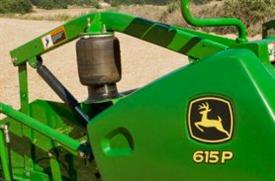 615P suspension system
615P suspension system

The exclusive FieldGlide suspension system features an adjustable air spring and heavy-duty hydraulic shock design to dampen movement during field operation, allowing the operator to increase harvesting speed. Once set, the air springs do not need adjustment during the season.
Feature benefit:
- Improves windrow harvesting performance
- Harvest at faster speeds
- No tools needed
Functionality
Adjustment of the air springs requires no tools and is simple compared to other belt pickup suspensions. Adjust the air springs according to instructions located on the belt pickup side sheets.
Hydraulic windscreen adjusts crop flow
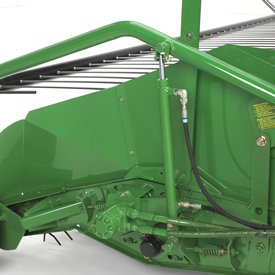 615P hydraulic windscreen
615P hydraulic windscreen

The hydraulic windscreen on the 615P allows the operator to maximize productivity by controlling the crop flow in changing windrow conditions.
Feature benefit:
- Adjustments made from the cab
- Control crop flow in changing windrow conditions
Functionality
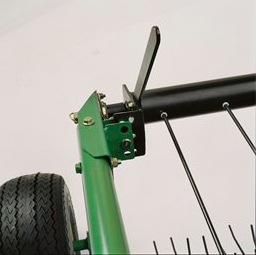 Manual tilt adjustment for windscreen
Manual tilt adjustment for windscreen

The hydraulic windscreen utilizes double-acting cylinders which react quicker in maximizing the control of the crop. The windscreen is controlled by the fore-and-aft control on the combine hydro handle. A benefit is the header backshaft speed can be controlled independently of the windscreen allowing for increased belt pickup, and auger/feederhouse chain speed for tough windrow conditions.
Dual draper belt enhances material flow
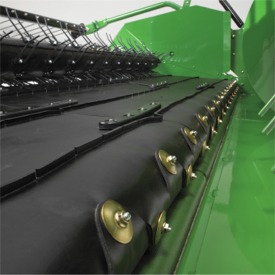 Crop transition on 615P
Crop transition on 615P

The 615P features a dual-belt draper to enhance material flow into the combine when harvesting windrows.
Feature benefit:
- Smooth material flow into the auger
- Increased material handling capacity
- Allows crop to fall from the pickup belts
Functionality
The transfer belts move crop under the 66-cm (26-in.) diameter auger. This provides significant material handling advantages in large/dense windrows.
4.5-m (14.8-ft) wide belt drives productivity in pickup
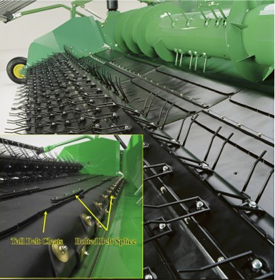 615P
615P
The 615P features 4.5-m (14.8-ft) wide belts for enhanced belt tracking with reduced seed loss.
Feature benefit:
- Eliminates the need for a complicated center-support roller
- Reduces seed loss
- Improved belt tracking
Functionality
Connectors between belts improve belt-drive capacity in tough windrow conditions without the need for a center support on the drive rollers. This design eliminates roller flanges which would create a gap between belts and could result in crop losses. The heavy-duty 615P belts are designed for maximum wear life.
Belt tracking and adjustment drive uptime
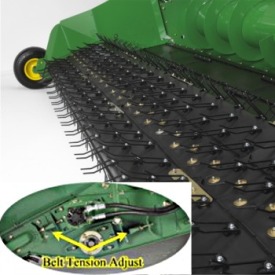 615P belt tensioning
615P belt tensioning

The 615P features a belt tensioning system for extended belt and roller life.
Feature benefit:
- Belts are evenly tensioned for uniformed loading
- Easy adjustment that requires minimal tools
- Minimizes seed loss
Features
Two available sizes for a 700D factory-installed center feed drum improves feeding of crop into the combine feederhouse
The center feed drum is designed for efficient and consistent feeding of the crop into the combine feederhouse. Beginning with model year 2020 700D Draper Platforms, customers will have the ability to choose between a 356-mm (14-in.) or 406-mm (16-in.) center feed drum to be factory installed.
Feature benefit:
- 356-mm (14-in.) or 406-mm (16-in.) diameter factory-installed feed drum significantly improves feeding of the crop
- Strategic location improves crop handling and capacity, increasing productivity in high-volume crops such as irrigated wheat, barley, or canola
- Combine performance is improved due to retractable fingers that enable smoother feeding
- Capacity increase in tough conditions by 20 percent due to an upgraded center feed section slip clutch
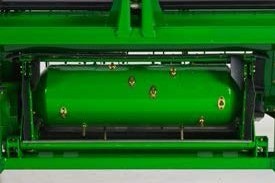 Center feed drum
Center feed drum
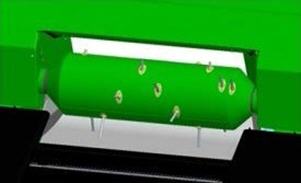 Feed drum retractable auger finger
Feed drum retractable auger finger
Functionality:
The feed drum protrudes forward from the draper back sheets, improving the crop handoff from the draper side belts. An increase in slip clutch torque of the center feed drum from 1200 Nm to 1650 Nm allows for increased capacity in tough crop conditions
In some crop conditions, crop can hesitate at the corners of the feed drum but the retractable drum fingers keep the crop moving into the combine.
Dual-knife drive system is timed
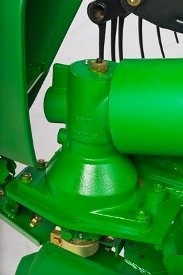 Cutterbar epicyclical gearcase
Cutterbar epicyclical gearcase
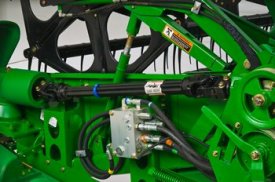 Knife drive shaft
Knife drive shaft
The unique dual-knife drive system is timed, creating the smoothest-possible reciprocating knife-drive system currently in the industry. The positive, reliable shaft-driven dual epicyclical in-line knife drives with built-in driveline protection, provide operators with the strongest knife-drive system.
Double-cut knife system produces a cleaner cut
All John Deere 700D Drapers include a double-cut knife which features a hydraulic tilt that is controlled from inside the cab. All 10.6-m (35-ft) and 12.1-m (40-ft) draper cutterbars have knifeback reinforcement straps to strengthen the knifeback.
Feature benefit:
- Maximized productivity through longer stroke of knife section provides a faster, cleaner, and smoother cut, which allows operators to harvest at faster ground speeds
- Productivity is maximized in tough conditions through a reinforced knifeback that strengthens the cutterbar
- Reduced cost of operation and increased wear life with hardened sickle sections and unique boron treatment
- Hydraulic tilt optimizes the cutterbar angle for varying conditions, extending the harvest day and providing the lowest-possible cut height
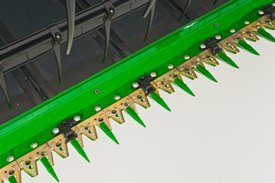 Double-cut cutterbar system
Double-cut cutterbar system
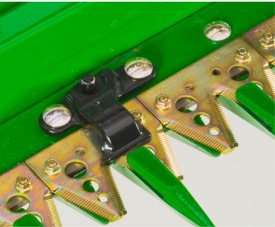 Double-cut rock guard
Double-cut rock guard
Functionality
The 100-mm (4-in.) cutting action produces a cleaner cut versus the tearing effect of shorter-stroke cutting systems. Knife hold-downs are easily adjusted to help maintain harvesting performance.
 Tilt cylinder
Tilt cylinder
The cutterbar hydraulic tilt adjusts a full 8 degrees while maintaining excellent visibility to the cutterbar throughout the tilt range. For improved ease of use, the hydro handle can be configured to control the platform tilt.
Reel resume and reverse are features on the 700D Drapers
Reel resume and reverse are features on the 700D Drapers. The combine operator can store two different reel positions with one setting for normal conditions and another for down, tangled, short, or leaning crops.
Feature benefit:
- Added time savings and convenience with saved reel positions, lowering operator fatigue
- Increased harvest efficiency through a reel-reverse feature which reverses the reel in conjunction with the center feed drum and belt to back outplugs
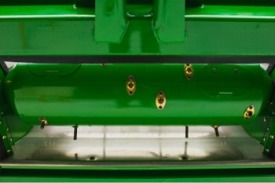 Draper drum
Draper drum
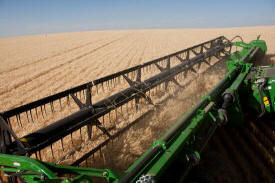 Draper reel
Draper reel
Draper feeding option for the 700D
A draper feeding option is available for model year 2018 that will be offered for the full 700D Rigid Draper lineup. This option code will include larger top crop augers with the necessary hydraulic components and mounting hardware as well as an improved seal kit to keep the grain in the draper and not left on the ground.
Feature benefit:
- Smoother feeding in tough crop conditions from a 50 percent increase in top crop auger diameter
- Increased performance in tough feeding crops with twice the torque on top crop auger motors
- 45 percent reduced center-feed section losses
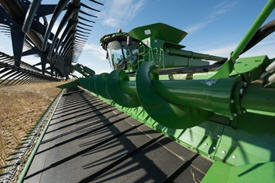
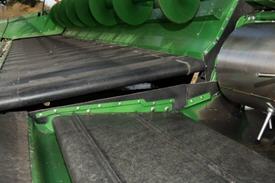

Functionality:
The top crop auger has been increased in size from 304.8 mm to 457.2 mm (12 in. to 18 in.) with deeper auger flighting to give increased control in bushy crop conditions. This results in even feeding to the center feed drum, which creates a smooth transition to the feederhouse. The seal kit for the center feed section has added rubber seals on both sides of the center feed drum, preventing losses from grain falling outside of the center feed drum.
Takes one person a few minutes to convert draper from field to transport without use of tools
The 730D, 735D, and 740D Draper models can be equipped with an integrated, slow-speed transport system.
John Deere value:
Need for a header trailer is eliminated due to dual-front dolly wheel tires with an extendable tongue and two-gauge wheel tires that can carry the complete weight of the draper when in transport
Road transport is quicker and easier because one person can convert the draper from field to transport mode in a few minutes without the use of tools
Theory of operation
In field mode, the dual wheels become the left- and right-hand gauge wheels. For transport, the left-hand dual-dolly wheels support one side of the draper frame and the right-hand dual wheels are repositioned to support the right-hand end of the frame.
The transport package includes warning lights, which can be plugged into a seven-way power source for road transport with a 32.2-km/h (20-mph) speed limit for farm equipment transport.
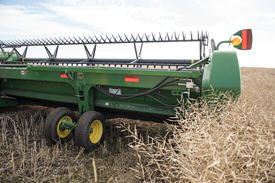 Dual-wheel arm and single-wheel arm assembly
Dual-wheel arm and single-wheel arm assembly
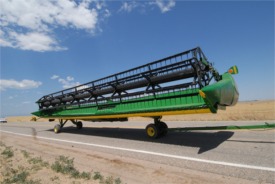 Slow-speed transport - rear wheels
Slow-speed transport - rear wheels
NOTE: The 730D, 735D, and 740D Drapers are equipped with two ST215/75R14 gauge wheel tires as base equipment and four ST215/75D14 gauge wheels with the low-speed transport option.
Features
Two available sizes for a 700D factory-installed center feed drum improves feeding of crop into the combine feederhouse
The center feed drum is designed for efficient and consistent feeding of the crop into the combine feederhouse. Beginning with model year 2020 700D Draper Platforms, customers will have the ability to choose between a 356-mm (14-in.) or 406-mm (16-in.) center feed drum to be factory installed.
Feature benefit:
- 356-mm (14-in.) or 406-mm (16-in.) diameter factory-installed feed drum significantly improves feeding of the crop
- Strategic location improves crop handling and capacity, increasing productivity in high-volume crops such as irrigated wheat, barley, or canola
- Combine performance is improved due to retractable fingers that enable smoother feeding
- Capacity increase in tough conditions by 20 percent due to an upgraded center feed section slip clutch
 Center feed drum
Center feed drum
 Feed drum retractable auger finger
Feed drum retractable auger finger
Functionality:
The feed drum protrudes forward from the draper back sheets, improving the crop handoff from the draper side belts. An increase in slip clutch torque of the center feed drum from 1200 Nm to 1650 Nm allows for increased capacity in tough crop conditions
In some crop conditions, crop can hesitate at the corners of the feed drum but the retractable drum fingers keep the crop moving into the combine.
Takes one person a few minutes to convert draper from field to transport without use of tools
The 730D, 735D, and 740D Draper models can be equipped with an integrated, slow-speed transport system.
John Deere value:
Need for a header trailer is eliminated due to dual-front dolly wheel tires with an extendable tongue and two-gauge wheel tires that can carry the complete weight of the draper when in transport
Road transport is quicker and easier because one person can convert the draper from field to transport mode in a few minutes without the use of tools
Theory of operation
In field mode, the dual wheels become the left- and right-hand gauge wheels. For transport, the left-hand dual-dolly wheels support one side of the draper frame and the right-hand dual wheels are repositioned to support the right-hand end of the frame.
The transport package includes warning lights, which can be plugged into a seven-way power source for road transport with a 32.2-km/h (20-mph) speed limit for farm equipment transport.
 Dual-wheel arm and single-wheel arm assembly
Dual-wheel arm and single-wheel arm assembly
 Slow-speed transport - rear wheels
Slow-speed transport - rear wheels
NOTE: The 730D, 735D, and 740D Drapers are equipped with two ST215/75R14 gauge wheel tires as base equipment and four ST215/75D14 gauge wheels with the low-speed transport option.
Dual-knife drive system is timed
 Cutterbar epicyclical gearcase
Cutterbar epicyclical gearcase
 Knife drive shaft
Knife drive shaft
The unique dual-knife drive system is timed, creating the smoothest-possible reciprocating knife-drive system currently in the industry. The positive, reliable shaft-driven dual epicyclical in-line knife drives with built-in driveline protection, provide operators with the strongest knife-drive system.
Double-cut knife system produces a cleaner cut
All John Deere 700D Drapers include a double-cut knife which features a hydraulic tilt that is controlled from inside the cab. All 10.6-m (35-ft) and 12.1-m (40-ft) draper cutterbars have knifeback reinforcement straps to strengthen the knifeback.
Feature benefit:
- Maximized productivity through longer stroke of knife section provides a faster, cleaner, and smoother cut, which allows operators to harvest at faster ground speeds
- Productivity is maximized in tough conditions through a reinforced knifeback that strengthens the cutterbar
- Reduced cost of operation and increased wear life with hardened sickle sections and unique boron treatment
- Hydraulic tilt optimizes the cutterbar angle for varying conditions, extending the harvest day and providing the lowest-possible cut height
 Double-cut cutterbar system
Double-cut cutterbar system
 Double-cut rock guard
Double-cut rock guard
Functionality
The 100-mm (4-in.) cutting action produces a cleaner cut versus the tearing effect of shorter-stroke cutting systems. Knife hold-downs are easily adjusted to help maintain harvesting performance.
 Tilt cylinder
Tilt cylinder
The cutterbar hydraulic tilt adjusts a full 8 degrees while maintaining excellent visibility to the cutterbar throughout the tilt range. For improved ease of use, the hydro handle can be configured to control the platform tilt.
Reel resume and reverse are features on the 700D Drapers
Reel resume and reverse are features on the 700D Drapers. The combine operator can store two different reel positions with one setting for normal conditions and another for down, tangled, short, or leaning crops.
Feature benefit:
- Added time savings and convenience with saved reel positions, lowering operator fatigue
- Increased harvest efficiency through a reel-reverse feature which reverses the reel in conjunction with the center feed drum and belt to back outplugs
 Draper drum
Draper drum
 Draper reel
Draper reel
Features
Two available sizes for a 700D factory-installed center feed drum improves feeding of crop into the combine feederhouse
The center feed drum is designed for efficient and consistent feeding of the crop into the combine feederhouse. Beginning with model year 2020 700D Draper Platforms, customers will have the ability to choose between a 356-mm (14-in.) or 406-mm (16-in.) center feed drum to be factory installed.
Feature benefit:
- 356-mm (14-in.) or 406-mm (16-in.) diameter factory-installed feed drum significantly improves feeding of the crop
- Strategic location improves crop handling and capacity, increasing productivity in high-volume crops such as irrigated wheat, barley, or canola
- Combine performance is improved due to retractable fingers that enable smoother feeding
- Capacity increase in tough conditions by 20 percent due to an upgraded center feed section slip clutch
 Center feed drum
Center feed drum
 Feed drum retractable auger finger
Feed drum retractable auger finger
Functionality:
The feed drum protrudes forward from the draper back sheets, improving the crop handoff from the draper side belts. An increase in slip clutch torque of the center feed drum from 1200 Nm to 1650 Nm allows for increased capacity in tough crop conditions
In some crop conditions, crop can hesitate at the corners of the feed drum but the retractable drum fingers keep the crop moving into the combine.
Takes one person a few minutes to convert draper from field to transport without use of tools
The 730D, 735D, and 740D Draper models can be equipped with an integrated, slow-speed transport system.
John Deere value:
Need for a header trailer is eliminated due to dual-front dolly wheel tires with an extendable tongue and two-gauge wheel tires that can carry the complete weight of the draper when in transport
Road transport is quicker and easier because one person can convert the draper from field to transport mode in a few minutes without the use of tools
Theory of operation
In field mode, the dual wheels become the left- and right-hand gauge wheels. For transport, the left-hand dual-dolly wheels support one side of the draper frame and the right-hand dual wheels are repositioned to support the right-hand end of the frame.
The transport package includes warning lights, which can be plugged into a seven-way power source for road transport with a 32.2-km/h (20-mph) speed limit for farm equipment transport.
 Dual-wheel arm and single-wheel arm assembly
Dual-wheel arm and single-wheel arm assembly
 Slow-speed transport - rear wheels
Slow-speed transport - rear wheels
NOTE: The 730D, 735D, and 740D Drapers are equipped with two ST215/75R14 gauge wheel tires as base equipment and four ST215/75D14 gauge wheels with the low-speed transport option.
Dual-knife drive system is timed
 Cutterbar epicyclical gearcase
Cutterbar epicyclical gearcase
 Knife drive shaft
Knife drive shaft
The unique dual-knife drive system is timed, creating the smoothest-possible reciprocating knife-drive system currently in the industry. The positive, reliable shaft-driven dual epicyclical in-line knife drives with built-in driveline protection, provide operators with the strongest knife-drive system.
Double-cut knife system produces a cleaner cut
All John Deere 700D Drapers include a double-cut knife which features a hydraulic tilt that is controlled from inside the cab. All 10.6-m (35-ft) and 12.1-m (40-ft) draper cutterbars have knifeback reinforcement straps to strengthen the knifeback.
Feature benefit:
- Maximized productivity through longer stroke of knife section provides a faster, cleaner, and smoother cut, which allows operators to harvest at faster ground speeds
- Productivity is maximized in tough conditions through a reinforced knifeback that strengthens the cutterbar
- Reduced cost of operation and increased wear life with hardened sickle sections and unique boron treatment
- Hydraulic tilt optimizes the cutterbar angle for varying conditions, extending the harvest day and providing the lowest-possible cut height
 Double-cut cutterbar system
Double-cut cutterbar system
 Double-cut rock guard
Double-cut rock guard
Functionality
The 100-mm (4-in.) cutting action produces a cleaner cut versus the tearing effect of shorter-stroke cutting systems. Knife hold-downs are easily adjusted to help maintain harvesting performance.
 Tilt cylinder
Tilt cylinder
The cutterbar hydraulic tilt adjusts a full 8 degrees while maintaining excellent visibility to the cutterbar throughout the tilt range. For improved ease of use, the hydro handle can be configured to control the platform tilt.
Reel resume and reverse are features on the 700D Drapers
Reel resume and reverse are features on the 700D Drapers. The combine operator can store two different reel positions with one setting for normal conditions and another for down, tangled, short, or leaning crops.
Feature benefit:
- Added time savings and convenience with saved reel positions, lowering operator fatigue
- Increased harvest efficiency through a reel-reverse feature which reverses the reel in conjunction with the center feed drum and belt to back outplugs
 Draper drum
Draper drum
 Draper reel
Draper reel
Features
Two available sizes for a 700D factory-installed center feed drum improves feeding of crop into the combine feederhouse
The center feed drum is designed for efficient and consistent feeding of the crop into the combine feederhouse. Beginning with model year 2020 700D Draper Platforms, customers will have the ability to choose between a 356-mm (14-in.) or 406-mm (16-in.) center feed drum to be factory installed.
Feature benefit:
- 356-mm (14-in.) or 406-mm (16-in.) diameter factory-installed feed drum significantly improves feeding of the crop
- Strategic location improves crop handling and capacity, increasing productivity in high-volume crops such as irrigated wheat, barley, or canola
- Combine performance is improved due to retractable fingers that enable smoother feeding
- Capacity increase in tough conditions by 20 percent due to an upgraded center feed section slip clutch
 Center feed drum
Center feed drum
 Feed drum retractable auger finger
Feed drum retractable auger finger
Functionality:
The feed drum protrudes forward from the draper back sheets, improving the crop handoff from the draper side belts. An increase in slip clutch torque of the center feed drum from 1200 Nm to 1650 Nm allows for increased capacity in tough crop conditions
In some crop conditions, crop can hesitate at the corners of the feed drum but the retractable drum fingers keep the crop moving into the combine.
Takes one person a few minutes to convert draper from field to transport without use of tools
The 730D, 735D, and 740D Draper models can be equipped with an integrated, slow-speed transport system.
John Deere value:
Need for a header trailer is eliminated due to dual-front dolly wheel tires with an extendable tongue and two-gauge wheel tires that can carry the complete weight of the draper when in transport
Road transport is quicker and easier because one person can convert the draper from field to transport mode in a few minutes without the use of tools
Theory of operation
In field mode, the dual wheels become the left- and right-hand gauge wheels. For transport, the left-hand dual-dolly wheels support one side of the draper frame and the right-hand dual wheels are repositioned to support the right-hand end of the frame.
The transport package includes warning lights, which can be plugged into a seven-way power source for road transport with a 32.2-km/h (20-mph) speed limit for farm equipment transport.
 Dual-wheel arm and single-wheel arm assembly
Dual-wheel arm and single-wheel arm assembly
 Slow-speed transport - rear wheels
Slow-speed transport - rear wheels
NOTE: The 730D, 735D, and 740D Drapers are equipped with two ST215/75R14 gauge wheel tires as base equipment and four ST215/75D14 gauge wheels with the low-speed transport option.
Dual-knife drive system is timed
 Cutterbar epicyclical gearcase
Cutterbar epicyclical gearcase
 Knife drive shaft
Knife drive shaft
The unique dual-knife drive system is timed, creating the smoothest-possible reciprocating knife-drive system currently in the industry. The positive, reliable shaft-driven dual epicyclical in-line knife drives with built-in driveline protection, provide operators with the strongest knife-drive system.
Double-cut knife system produces a cleaner cut
All John Deere 700D Drapers include a double-cut knife which features a hydraulic tilt that is controlled from inside the cab. All 10.6-m (35-ft) and 12.1-m (40-ft) draper cutterbars have knifeback reinforcement straps to strengthen the knifeback.
Feature benefit:
- Maximized productivity through longer stroke of knife section provides a faster, cleaner, and smoother cut, which allows operators to harvest at faster ground speeds
- Productivity is maximized in tough conditions through a reinforced knifeback that strengthens the cutterbar
- Reduced cost of operation and increased wear life with hardened sickle sections and unique boron treatment
- Hydraulic tilt optimizes the cutterbar angle for varying conditions, extending the harvest day and providing the lowest-possible cut height
 Double-cut cutterbar system
Double-cut cutterbar system
 Double-cut rock guard
Double-cut rock guard
Functionality
The 100-mm (4-in.) cutting action produces a cleaner cut versus the tearing effect of shorter-stroke cutting systems. Knife hold-downs are easily adjusted to help maintain harvesting performance.
 Tilt cylinder
Tilt cylinder
The cutterbar hydraulic tilt adjusts a full 8 degrees while maintaining excellent visibility to the cutterbar throughout the tilt range. For improved ease of use, the hydro handle can be configured to control the platform tilt.
Reel resume and reverse are features on the 700D Drapers
Reel resume and reverse are features on the 700D Drapers. The combine operator can store two different reel positions with one setting for normal conditions and another for down, tangled, short, or leaning crops.
Feature benefit:
- Added time savings and convenience with saved reel positions, lowering operator fatigue
- Increased harvest efficiency through a reel-reverse feature which reverses the reel in conjunction with the center feed drum and belt to back outplugs
 Draper drum
Draper drum
 Draper reel
Draper reel
Features
Industry-exclusive HydraFlex™ technology on 700FD
The 700FD Series HydraFlex Draper Platform features HydraFlex, an industry-exclusive hydraulic float system allowing for superior ground following capabilities over a wide range of crops and conditions.
Feature benefit:
- The HydraFlex system hydraulically controls the float of the cutterbar by the turn of a knob in the cab for ease of operation
- Provides exceptional cutterbar flexibility throughout the entire working pressure range for increased machine performance
- Unique cutterbar float arms offer a dual purpose, allowing for superior ground-following capabilities plus support to the cutterbar and draper belts for increased productivity
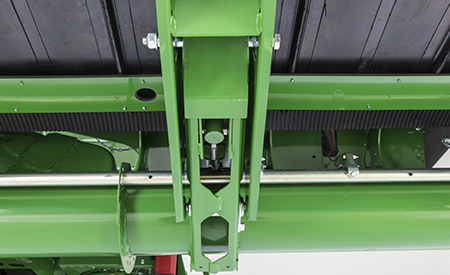 Hydraulic cylinder in the float arm
Hydraulic cylinder in the float arm
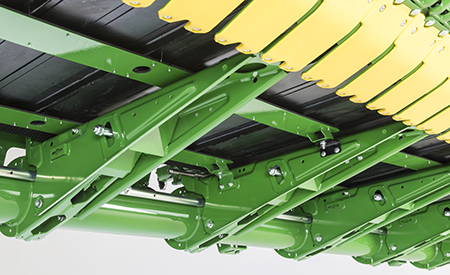 Float arm on 700FD
Float arm on 700FD
Functionality
From the cab, the operator can simply adjust the armrest encoder knob which varies the hydraulic pressure in the float arm hydraulic cylinders. This controls the cutterbar ground pressure depending upon conditions.
With the HydraFlex float system, the operator varies the cutterbar ground pressure but does not affect the cutting height of the crop, even at high ground speeds. The hydraulic float system features a 19-cm (7.5-in.) float range, allowing for optimum float pressure. To lock out the HydraFlex draper into rigid mode, the operator increases the float pressure to maximum.
Dual knife drive is timed
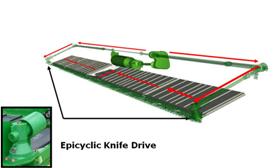 Dual knife drive
Dual knife drive
Dual knife drive is standard on 700FD HydraFlex™ Draper Platform for harvesting rice, tough crop, and wet or green crop conditions. This unique dual knife drive system is timed, creating the smoothest possible reciprocating knife drive system currently in the industry.
Positive, reliable, power take-off (PTO) shaft and driven, dual epicyclical in-line knife drives with built-in driveline protection provides producers with the strongest knife drive system in the industry.
NOTE: Single-knife drive is available on the 730FD, but increased cutterbar vibration may occur.
Increased versatility and productivity with a dual-position feed drum
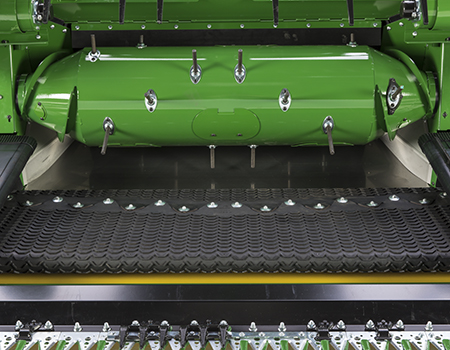 40.64-cm (16-in.) feed drum
40.64-cm (16-in.) feed drum
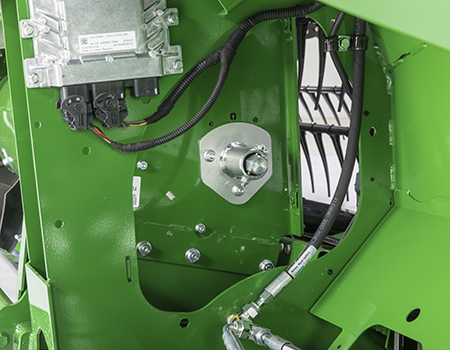 Make adjustments to raise or lower drum
Make adjustments to raise or lower drum
The 700FD now comes standard with a dual-position drum. This allows the operator to select an upper or lower setting, equivalent to a 40.6-cm (16-in.) drum and 35.6-cm (14-in.) drum, respectively. All 700FD Draper Platforms will ship from the factory with the drum in the 40.6-cm (16-in.) position, which is the standard position. For bushy crops, such as canola, putting the drum in the upper position will allow a greater throughput.
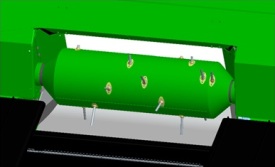 Feed drum retractable auger finger
Feed drum retractable auger finger
A feature for 700FD Draper Platforms is a feed drum retractable auger finger to improve crop feeding at the corners of the feed drum. In some crop conditions, the crop can hesitate at the corners of the feed drum, and the retractable drum fingers keep the crop moving into the combine. This results in smoother feeding and better performance of the combine.
Control belt speed, side belt speed reduction and integrated belt protection all from the cab
The speed of the side draper belts can be controlled by an adjustment on the CommandARM™ controls from within the cab. Combine software gives operators the option to slow down the side belts to a fixed speed with a push of a button on the CommandARM. Additionally, a draper belt protection system is integrated into the 700FD HydraFlex™ Draper Platform family to minimize side belt damage should slippage occur.
Feature benefit:
- Optimal performance in varying crops and conditions through side draper belt speed that ranges from 22.6 m/min to 228 m/min (74 fpm to 748 fpm) and shows on the display in the cab
- The center draper belt speed is fixed at 288 m/min (944.9 fpm) for optimal feeding to the combine feederhouse
- Speed sensors monitor the speed of the idler rollers and should major slippage be experienced, the belts will shut off and an operator warning is shown on the 4600 CommandCenter™ display
- Side belt speed reduction is designed to improve draper performance when the operator is not harvesting the full platform width or when coming out of a headland
- Increased uptime as the side belt speed reduction feature is engaged/disengaged from the CommandARM controls
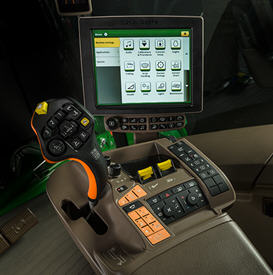 CommandARM controls for S700 Series Combines
CommandARM controls for S700 Series Combines
Top-crop conveying auger keeps bushy crops moving into the feederhouse
The 700FD HydraFlex™ Drapers offer an optional 45.7-cm (18-in.) top-crop conveying auger extending the full width of the draper to help bushy crops, especially heavy canola, feed evenly into the feederhouse.
Feature benefit:
- Maximum productivity due to smooth feeding of bushy crops such as canola that stall over the side draper belts
- Minimum time and effort required to install for bushy crops or remove for traditional crops for optimal performance in both conditions
- Available as a stand-alone option or as part of the draper feeding option with the center section seal kit for maximum performance in canola
 Top-crop conveying auger
Top-crop conveying auger
Functionality:
This optional 45.7-cm (18-in.) hydraulically driven top auger has an easy speed adjustment at the right side of the platform.
It is recommended for operation in bushy or high-volume harvesting conditions such as canola.
Features
Industry-exclusive HydraFlex™ technology on 700FD
The 700FD Series HydraFlex Draper Platform features HydraFlex, an industry-exclusive hydraulic float system allowing for superior ground following capabilities over a wide range of crops and conditions.
Feature benefit:
- The HydraFlex system hydraulically controls the float of the cutterbar by the turn of a knob in the cab for ease of operation
- Provides exceptional cutterbar flexibility throughout the entire working pressure range for increased machine performance
- Unique cutterbar float arms offer a dual purpose, allowing for superior ground-following capabilities plus support to the cutterbar and draper belts for increased productivity
 Hydraulic cylinder in the float arm
Hydraulic cylinder in the float arm
 Float arm on 700FD
Float arm on 700FD
Functionality
From the cab, the operator can simply adjust the armrest encoder knob which varies the hydraulic pressure in the float arm hydraulic cylinders. This controls the cutterbar ground pressure depending upon conditions.
With the HydraFlex float system, the operator varies the cutterbar ground pressure but does not affect the cutting height of the crop, even at high ground speeds. The hydraulic float system features a 19-cm (7.5-in.) float range, allowing for optimum float pressure. To lock out the HydraFlex draper into rigid mode, the operator increases the float pressure to maximum.
Dual knife drive is timed
 Dual knife drive
Dual knife drive
Dual knife drive is standard on 700FD HydraFlex™ Draper Platform for harvesting rice, tough crop, and wet or green crop conditions. This unique dual knife drive system is timed, creating the smoothest possible reciprocating knife drive system currently in the industry.
Positive, reliable, power take-off (PTO) shaft and driven, dual epicyclical in-line knife drives with built-in driveline protection provides producers with the strongest knife drive system in the industry.
NOTE: Single-knife drive is available on the 730FD, but increased cutterbar vibration may occur.
Increased versatility and productivity with a dual-position feed drum
 40.64-cm (16-in.) feed drum
40.64-cm (16-in.) feed drum
 Make adjustments to raise or lower drum
Make adjustments to raise or lower drum
The 700FD now comes standard with a dual-position drum. This allows the operator to select an upper or lower setting, equivalent to a 40.6-cm (16-in.) drum and 35.6-cm (14-in.) drum, respectively. All 700FD Draper Platforms will ship from the factory with the drum in the 40.6-cm (16-in.) position, which is the standard position. For bushy crops, such as canola, putting the drum in the upper position will allow a greater throughput.
 Feed drum retractable auger finger
Feed drum retractable auger finger
A feature for 700FD Draper Platforms is a feed drum retractable auger finger to improve crop feeding at the corners of the feed drum. In some crop conditions, the crop can hesitate at the corners of the feed drum, and the retractable drum fingers keep the crop moving into the combine. This results in smoother feeding and better performance of the combine.
Control belt speed, side belt speed reduction and integrated belt protection all from the cab
The speed of the side draper belts can be controlled by an adjustment on the CommandARM™ controls from within the cab. Combine software gives operators the option to slow down the side belts to a fixed speed with a push of a button on the CommandARM. Additionally, a draper belt protection system is integrated into the 700FD HydraFlex™ Draper Platform family to minimize side belt damage should slippage occur.
Feature benefit:
- Optimal performance in varying crops and conditions through side draper belt speed that ranges from 22.6 m/min to 228 m/min (74 fpm to 748 fpm) and shows on the display in the cab
- The center draper belt speed is fixed at 288 m/min (944.9 fpm) for optimal feeding to the combine feederhouse
- Speed sensors monitor the speed of the idler rollers and should major slippage be experienced, the belts will shut off and an operator warning is shown on the 4600 CommandCenter™ display
- Side belt speed reduction is designed to improve draper performance when the operator is not harvesting the full platform width or when coming out of a headland
- Increased uptime as the side belt speed reduction feature is engaged/disengaged from the CommandARM controls
 CommandARM controls for S700 Series Combines
CommandARM controls for S700 Series Combines
Top-crop conveying auger keeps bushy crops moving into the feederhouse
The 700FD HydraFlex™ Drapers offer an optional 45.7-cm (18-in.) top-crop conveying auger extending the full width of the draper to help bushy crops, especially heavy canola, feed evenly into the feederhouse.
Feature benefit:
- Maximum productivity due to smooth feeding of bushy crops such as canola that stall over the side draper belts
- Minimum time and effort required to install for bushy crops or remove for traditional crops for optimal performance in both conditions
- Available as a stand-alone option or as part of the draper feeding option with the center section seal kit for maximum performance in canola
 Top-crop conveying auger
Top-crop conveying auger
Functionality:
This optional 45.7-cm (18-in.) hydraulically driven top auger has an easy speed adjustment at the right side of the platform.
It is recommended for operation in bushy or high-volume harvesting conditions such as canola.
Features
Industry-exclusive HydraFlex™ technology on 700FD
The 700FD Series HydraFlex Draper Platform features HydraFlex, an industry-exclusive hydraulic float system allowing for superior ground following capabilities over a wide range of crops and conditions.
Feature benefit:
- The HydraFlex system hydraulically controls the float of the cutterbar by the turn of a knob in the cab for ease of operation
- Provides exceptional cutterbar flexibility throughout the entire working pressure range for increased machine performance
- Unique cutterbar float arms offer a dual purpose, allowing for superior ground-following capabilities plus support to the cutterbar and draper belts for increased productivity
 Hydraulic cylinder in the float arm
Hydraulic cylinder in the float arm
 Float arm on 700FD
Float arm on 700FD
Functionality
From the cab, the operator can simply adjust the armrest encoder knob which varies the hydraulic pressure in the float arm hydraulic cylinders. This controls the cutterbar ground pressure depending upon conditions.
With the HydraFlex float system, the operator varies the cutterbar ground pressure but does not affect the cutting height of the crop, even at high ground speeds. The hydraulic float system features a 19-cm (7.5-in.) float range, allowing for optimum float pressure. To lock out the HydraFlex draper into rigid mode, the operator increases the float pressure to maximum.
Dual knife drive is timed
 Dual knife drive
Dual knife drive
Dual knife drive is standard on 700FD HydraFlex™ Draper Platform for harvesting rice, tough crop, and wet or green crop conditions. This unique dual knife drive system is timed, creating the smoothest possible reciprocating knife drive system currently in the industry.
Positive, reliable, power take-off (PTO) shaft and driven, dual epicyclical in-line knife drives with built-in driveline protection provides producers with the strongest knife drive system in the industry.
NOTE: Single-knife drive is available on the 730FD, but increased cutterbar vibration may occur.
Increased versatility and productivity with a dual-position feed drum
 40.64-cm (16-in.) feed drum
40.64-cm (16-in.) feed drum
 Make adjustments to raise or lower drum
Make adjustments to raise or lower drum
The 700FD now comes standard with a dual-position drum. This allows the operator to select an upper or lower setting, equivalent to a 40.6-cm (16-in.) drum and 35.6-cm (14-in.) drum, respectively. All 700FD Draper Platforms will ship from the factory with the drum in the 40.6-cm (16-in.) position, which is the standard position. For bushy crops, such as canola, putting the drum in the upper position will allow a greater throughput.
 Feed drum retractable auger finger
Feed drum retractable auger finger
A feature for 700FD Draper Platforms is a feed drum retractable auger finger to improve crop feeding at the corners of the feed drum. In some crop conditions, the crop can hesitate at the corners of the feed drum, and the retractable drum fingers keep the crop moving into the combine. This results in smoother feeding and better performance of the combine.
Control belt speed, side belt speed reduction and integrated belt protection all from the cab
The speed of the side draper belts can be controlled by an adjustment on the CommandARM™ controls from within the cab. Combine software gives operators the option to slow down the side belts to a fixed speed with a push of a button on the CommandARM. Additionally, a draper belt protection system is integrated into the 700FD HydraFlex™ Draper Platform family to minimize side belt damage should slippage occur.
Feature benefit:
- Optimal performance in varying crops and conditions through side draper belt speed that ranges from 22.6 m/min to 228 m/min (74 fpm to 748 fpm) and shows on the display in the cab
- The center draper belt speed is fixed at 288 m/min (944.9 fpm) for optimal feeding to the combine feederhouse
- Speed sensors monitor the speed of the idler rollers and should major slippage be experienced, the belts will shut off and an operator warning is shown on the 4600 CommandCenter™ display
- Side belt speed reduction is designed to improve draper performance when the operator is not harvesting the full platform width or when coming out of a headland
- Increased uptime as the side belt speed reduction feature is engaged/disengaged from the CommandARM controls
 CommandARM controls for S700 Series Combines
CommandARM controls for S700 Series Combines
Top-crop conveying auger keeps bushy crops moving into the feederhouse
The 700FD HydraFlex™ Drapers offer an optional 45.7-cm (18-in.) top-crop conveying auger extending the full width of the draper to help bushy crops, especially heavy canola, feed evenly into the feederhouse.
Feature benefit:
- Maximum productivity due to smooth feeding of bushy crops such as canola that stall over the side draper belts
- Minimum time and effort required to install for bushy crops or remove for traditional crops for optimal performance in both conditions
- Available as a stand-alone option or as part of the draper feeding option with the center section seal kit for maximum performance in canola
 Top-crop conveying auger
Top-crop conveying auger
Functionality:
This optional 45.7-cm (18-in.) hydraulically driven top auger has an easy speed adjustment at the right side of the platform.
It is recommended for operation in bushy or high-volume harvesting conditions such as canola.
Features
Industry-exclusive HydraFlex™ technology on 700FD
The 700FD Series HydraFlex Draper Platform features HydraFlex, an industry-exclusive hydraulic float system allowing for superior ground following capabilities over a wide range of crops and conditions.
Feature benefit:
- The HydraFlex system hydraulically controls the float of the cutterbar by the turn of a knob in the cab for ease of operation
- Provides exceptional cutterbar flexibility throughout the entire working pressure range for increased machine performance
- Unique cutterbar float arms offer a dual purpose, allowing for superior ground-following capabilities plus support to the cutterbar and draper belts for increased productivity
 Hydraulic cylinder in the float arm
Hydraulic cylinder in the float arm
 Float arm on 700FD
Float arm on 700FD
Functionality
From the cab, the operator can simply adjust the armrest encoder knob which varies the hydraulic pressure in the float arm hydraulic cylinders. This controls the cutterbar ground pressure depending upon conditions.
With the HydraFlex float system, the operator varies the cutterbar ground pressure but does not affect the cutting height of the crop, even at high ground speeds. The hydraulic float system features a 19-cm (7.5-in.) float range, allowing for optimum float pressure. To lock out the HydraFlex draper into rigid mode, the operator increases the float pressure to maximum.
Dual knife drive is timed
 Dual knife drive
Dual knife drive
Dual knife drive is standard on 700FD HydraFlex™ Draper Platform for harvesting rice, tough crop, and wet or green crop conditions. This unique dual knife drive system is timed, creating the smoothest possible reciprocating knife drive system currently in the industry.
Positive, reliable, power take-off (PTO) shaft and driven, dual epicyclical in-line knife drives with built-in driveline protection provides producers with the strongest knife drive system in the industry.
NOTE: Single-knife drive is available on the 730FD, but increased cutterbar vibration may occur.
Increased versatility and productivity with a dual-position feed drum
 40.64-cm (16-in.) feed drum
40.64-cm (16-in.) feed drum
 Make adjustments to raise or lower drum
Make adjustments to raise or lower drum
The 700FD now comes standard with a dual-position drum. This allows the operator to select an upper or lower setting, equivalent to a 40.6-cm (16-in.) drum and 35.6-cm (14-in.) drum, respectively. All 700FD Draper Platforms will ship from the factory with the drum in the 40.6-cm (16-in.) position, which is the standard position. For bushy crops, such as canola, putting the drum in the upper position will allow a greater throughput.
 Feed drum retractable auger finger
Feed drum retractable auger finger
A feature for 700FD Draper Platforms is a feed drum retractable auger finger to improve crop feeding at the corners of the feed drum. In some crop conditions, the crop can hesitate at the corners of the feed drum, and the retractable drum fingers keep the crop moving into the combine. This results in smoother feeding and better performance of the combine.
Control belt speed, side belt speed reduction and integrated belt protection all from the cab
The speed of the side draper belts can be controlled by an adjustment on the CommandARM™ controls from within the cab. Combine software gives operators the option to slow down the side belts to a fixed speed with a push of a button on the CommandARM. Additionally, a draper belt protection system is integrated into the 700FD HydraFlex™ Draper Platform family to minimize side belt damage should slippage occur.
Feature benefit:
- Optimal performance in varying crops and conditions through side draper belt speed that ranges from 22.6 m/min to 228 m/min (74 fpm to 748 fpm) and shows on the display in the cab
- The center draper belt speed is fixed at 288 m/min (944.9 fpm) for optimal feeding to the combine feederhouse
- Speed sensors monitor the speed of the idler rollers and should major slippage be experienced, the belts will shut off and an operator warning is shown on the 4600 CommandCenter™ display
- Side belt speed reduction is designed to improve draper performance when the operator is not harvesting the full platform width or when coming out of a headland
- Increased uptime as the side belt speed reduction feature is engaged/disengaged from the CommandARM controls
 CommandARM controls for S700 Series Combines
CommandARM controls for S700 Series Combines
Top-crop conveying auger keeps bushy crops moving into the feederhouse
The 700FD HydraFlex™ Drapers offer an optional 45.7-cm (18-in.) top-crop conveying auger extending the full width of the draper to help bushy crops, especially heavy canola, feed evenly into the feederhouse.
Feature benefit:
- Maximum productivity due to smooth feeding of bushy crops such as canola that stall over the side draper belts
- Minimum time and effort required to install for bushy crops or remove for traditional crops for optimal performance in both conditions
- Available as a stand-alone option or as part of the draper feeding option with the center section seal kit for maximum performance in canola
 Top-crop conveying auger
Top-crop conveying auger
Functionality:
This optional 45.7-cm (18-in.) hydraulically driven top auger has an easy speed adjustment at the right side of the platform.
It is recommended for operation in bushy or high-volume harvesting conditions such as canola.
Features
RowMax™ stalk roll options for a variety of customer needs
Customers have asked for stalk rolls to appropriately size residue for their operation while managing power and overall header weight.
John Deere offers RowMax stalk rolls to address customer needs around residue, power, and weight for their front-end equipment.
RowMax stalk roll features and benefits:
- RowMax stalk rolls can improve wear life by 25 to 30 percent compared to the 600C base stalk rolls.
- Three stalk roll options allow customers to select the appropriate length of corn stalk residue.
- To provide high performance during harvest, RowMax stalk rolls are designed with reduced power and fuel consumption in mind.
- RowMax Chopping Stalk Roll drops stalk residue on top of the row for improved planting performance for no-till and strip-till customers the following season. Additionally, the chopping stalk roll blossoms the top of the stalk for reduced tire and track damage.
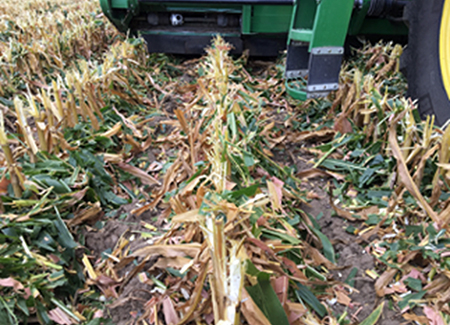 Stalk residue dropped on top of the row
Stalk residue dropped on top of the row
 Top of the stalk is blossomed
Top of the stalk is blossomed
RowMax stalk roll details:
- The stalk rolls are manufactured from highly durable austempered ductile iron material with an added wear coating for increased wear life.
- The full-length blades provide total crop contact for appropriate sizing and cutting action from front to back.
- Stalk roll tip speed compared to gathering chain speed is optimized to reduce material-other-than-grain (MOG) intake and increase overall capacity while minimizing losses.
- Enclosed chain drives gathering chains and stalk rolls for each row to provide robust durability and uninterrupted harvesting.
- Single-piece cast knife roll design provides excellent serviceability when replacement is required.
 Row-unit
Row-unit
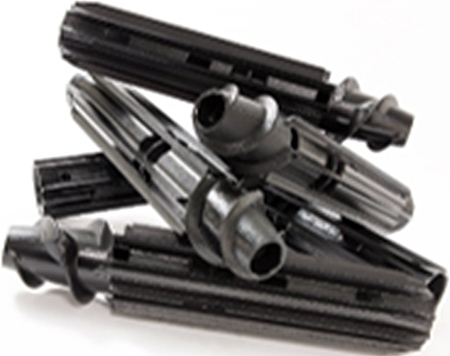 Single-piece cast knife roll
Single-piece cast knife roll
Choosing the correct RowMax stalk roll
| Stalk rolls without StalkMaster™ corn heads |
RowMax Opposed | RowMax Intermeshing | RowMax Chopping |
| Knife alignment |  |
 |
 |
| Residue size | Good | Good | Better |
| Residue breakdown | Fast | Faster | Fastest |
| Soil warm up/dry down | Fast | Faster | Fastest |
| Wear life | Better | Better | Best |
| Row unit power consumption | Best | Better | Better |
| Fuel consumption | Best | Better | Good |
| Trash intake | Best | Better | Better |
| Dry stalks | Best | Good | Good |
| Wet stalks | Best | Better | Better |
| Down corn | Best | Good | Good |
| Weight for two stalk rolls | 17.2 kg (38 lb) | 18.1 kg (40 lb) | 19.5 kg (43 lb) |
| StalkMaster with RowMax opposed stalk roll | |||
| Residue size | Best | ||
| Row unit power consumption vs. opposed without StalkMaster | Good | ||
| Weight | Additional 19.1 kg (42 lb) per row for StalkMaster components | ||
| General stalk roll parts information | |||
| Number of knives | 8 | 6 | 10 |
| Aftermarket part numbers* (left hand) | HXE110671 | HXE110675 | HXE141569 |
| Aftermarket part numbers* (right hand) | HXE110672 | HXE110676 | HXE141570 |
| Compatibility | Model year 2012 and newer 600C/600FC and 700C/700FC for StalkMaster and non StalkMaster row units; factory-installed option code for model year 2020 Corn Heads |
||
*NOTE: Part numbers are subject to change. Please check the parts order before completing the transaction.
RowMax™ row-unit kit for 700C/FC and 600C/FC Corn Heads
The 700C/FC Corn Head RowMax row-unit provides customers increased durability and longer wear life. RowMax row-units include updates to gathering chains, gathering chain sprockets, chain guides, and stalk rolls. These improvements extend the life of the corn head for lower ownership cost.
Feature benefit:
- Increased wear life of row-unit gathering chains and sprockets by 50 percent due to solid alloy pin bushings and increased number of sprocket teeth
- Increased wear life of stalk rolls up to 30 percent with an improved wear coating
- Maintain corn head performance durability with an increase in stalk roll material hardness
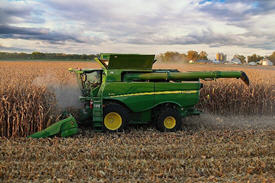 RowMax row-unit
RowMax row-unit
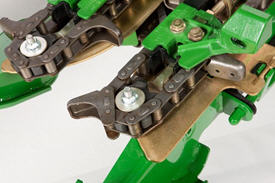 Gathering chain and sprocket
Gathering chain and sprocket
Functionality:
To extend the life of the corn head, the RowMax row-unit increases the number of sprocket teeth on gathering chains from six teeth to eight teeth. The gathering chain has an additional 12 links and an anti-bend back feature on the chain lug. Gathering chain wear is reduced by using a solid alloy bushing.
StalkMaster™ row-unit enables a high level of stalk residue processing
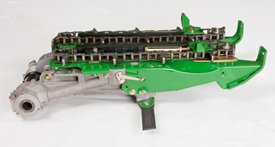 StalkMaster row-unit
StalkMaster row-unit
Available as an option, StalkMaster provides ultimate stalk sizing by processing stalks smaller than stalk rolls allowing the operator to potentially eliminate second-pass operations, saving time, fuel, labor, and additional operating costs.
Feature benefit:
- Consistent sizing of corn stalks to speed up decomposition and provide soil protection from blowing wind and water runoff
- StalkMaster can be equipped with either intermeshing, opposed, or chopping stalk rolls
- Ultimate flexibility to chop or not chop when desired through a quick, no-tools-required disconnect feature
Functionality
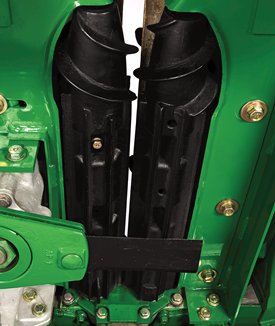 StalkMaster blades
StalkMaster blades
Each StalkMaster row-unit gearcase is equipped with two heat-treated and wear-coated rotating blades positioned below the stalk rolls. The blades can be reversed to extend their wear life. These blades cut stalk to size and distribute residue evenly throughout the row. If the blades encounter an obstruction they will swing backward, avoiding damage and interruption to harvest.
 StalkMaster disconnect feature
StalkMaster disconnect feature
The StalkMaster row-unit gearcase feature a no-tools-required disconnect. Each row has a lever on the right side of the gearcase to turn the function on or off in a matter of minutes if desired, allowing for lower fuel consumption.
 StalkMaster gearcase
StalkMaster gearcase
A heavy-duty slip-clutch design protects the row-unit gearcase and the StalkMaster lower unit gearcase.
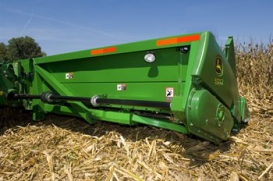 712C right-hand side and drive shaft
712C right-hand side and drive shaft
The gathering chains and stalk rolls for each row are enclosed to provide robust durability. Heavy-duty bearings along with O-ring seals improve serviceability.
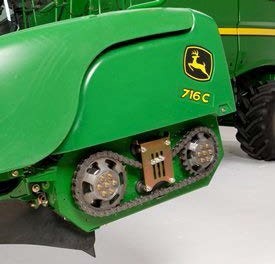 Larger sprockets and chain
Larger sprockets and chain
A continuous-loop chain allows higher loads and longer life by eliminating all connector links and half links. The large-diameter sprockets along with a large 38-mm (1.50-in.) transverse hex back shaft and row-unit shaft provide improved sprocket and chain.
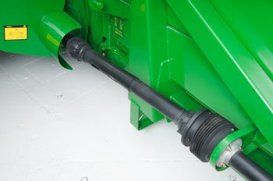 Telescoping drive shaft
Telescoping drive shaft
A telescoping drive shaft mounts to the splined feederhouse back shaft on all 50, 60, 70, W-, T-, C-, and S-Series Combines.
The coupler features an 8-degree index, allowing the customer to match the drive shaft splines without rotating the platform feederhouse.
Telescoping drive shafts can be retrofitted to earlier 90 Series and 40 Series Corn Heads.
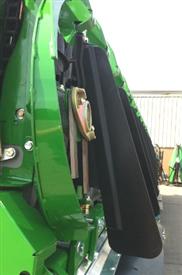 Rubberized curtains
Rubberized curtains
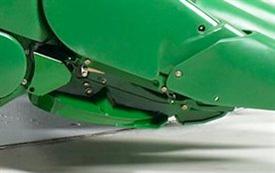 Steel-protective shield
Steel-protective shield
StalkMaster row units feature side- and rear-mounted rubberized curtains to optimize residue distribution. The right-hand side of the head has an additional shield to protect customers from protruding blades.
AutoTrac™ RowSense™ enables hands-free corn harvest
 Feelers keep the combine on the row
Feelers keep the combine on the row
AutoTrac RowSense, an innovative global positioning system (GPS) steering system, reduces overlap and fatigue during harvest.
Feature benefit:
- Continue harvesting in down crop and dusty conditions
- Increases acre-per-hour potential and reduce grain loss
- Enhances operator comfort while reducing stress
Functionality
 StarFire™ position receiver picks up signal
StarFire™ position receiver picks up signal
Features
RowMax™ stalk roll options for a variety of customer needs
Customers have asked for stalk rolls to appropriately size residue for their operation while managing power and overall header weight.
John Deere offers RowMax stalk rolls to address customer needs around residue, power, and weight for their front-end equipment.
RowMax stalk roll features and benefits:
- RowMax stalk rolls can improve wear life by 25 to 30 percent compared to the 600C base stalk rolls.
- Three stalk roll options allow customers to select the appropriate length of corn stalk residue.
- To provide high performance during harvest, RowMax stalk rolls are designed with reduced power and fuel consumption in mind.
- RowMax Chopping Stalk Roll drops stalk residue on top of the row for improved planting performance for no-till and strip-till customers the following season. Additionally, the chopping stalk roll blossoms the top of the stalk for reduced tire and track damage.
 Stalk residue dropped on top of the row
Stalk residue dropped on top of the row
 Top of the stalk is blossomed
Top of the stalk is blossomed
RowMax stalk roll details:
- The stalk rolls are manufactured from highly durable austempered ductile iron material with an added wear coating for increased wear life.
- The full-length blades provide total crop contact for appropriate sizing and cutting action from front to back.
- Stalk roll tip speed compared to gathering chain speed is optimized to reduce material-other-than-grain (MOG) intake and increase overall capacity while minimizing losses.
- Enclosed chain drives gathering chains and stalk rolls for each row to provide robust durability and uninterrupted harvesting.
- Single-piece cast knife roll design provides excellent serviceability when replacement is required.
 Row-unit
Row-unit
 Single-piece cast knife roll
Single-piece cast knife roll
Choosing the correct RowMax stalk roll
| Stalk rolls without StalkMaster™ corn heads |
RowMax Opposed | RowMax Intermeshing | RowMax Chopping |
| Knife alignment |  |
 |
 |
| Residue size | Good | Good | Better |
| Residue breakdown | Fast | Faster | Fastest |
| Soil warm up/dry down | Fast | Faster | Fastest |
| Wear life | Better | Better | Best |
| Row unit power consumption | Best | Better | Better |
| Fuel consumption | Best | Better | Good |
| Trash intake | Best | Better | Better |
| Dry stalks | Best | Good | Good |
| Wet stalks | Best | Better | Better |
| Down corn | Best | Good | Good |
| Weight for two stalk rolls | 17.2 kg (38 lb) | 18.1 kg (40 lb) | 19.5 kg (43 lb) |
| StalkMaster with RowMax opposed stalk roll | |||
| Residue size | Best | ||
| Row unit power consumption vs. opposed without StalkMaster | Good | ||
| Weight | Additional 19.1 kg (42 lb) per row for StalkMaster components | ||
| General stalk roll parts information | |||
| Number of knives | 8 | 6 | 10 |
| Aftermarket part numbers* (left hand) | HXE110671 | HXE110675 | HXE141569 |
| Aftermarket part numbers* (right hand) | HXE110672 | HXE110676 | HXE141570 |
| Compatibility | Model year 2012 and newer 600C/600FC and 700C/700FC for StalkMaster and non StalkMaster row units; factory-installed option code for model year 2020 Corn Heads |
||
*NOTE: Part numbers are subject to change. Please check the parts order before completing the transaction.
RowMax™ row-unit kit for 700C/FC and 600C/FC Corn Heads
The 700C/FC Corn Head RowMax row-unit provides customers increased durability and longer wear life. RowMax row-units include updates to gathering chains, gathering chain sprockets, chain guides, and stalk rolls. These improvements extend the life of the corn head for lower ownership cost.
Feature benefit:
- Increased wear life of row-unit gathering chains and sprockets by 50 percent due to solid alloy pin bushings and increased number of sprocket teeth
- Increased wear life of stalk rolls up to 30 percent with an improved wear coating
- Maintain corn head performance durability with an increase in stalk roll material hardness
 RowMax row-unit
RowMax row-unit
 Gathering chain and sprocket
Gathering chain and sprocket
Functionality:
To extend the life of the corn head, the RowMax row-unit increases the number of sprocket teeth on gathering chains from six teeth to eight teeth. The gathering chain has an additional 12 links and an anti-bend back feature on the chain lug. Gathering chain wear is reduced by using a solid alloy bushing.
StalkMaster™ row-unit enables a high level of stalk residue processing
 StalkMaster row-unit
StalkMaster row-unit
Available as an option, StalkMaster provides ultimate stalk sizing by processing stalks smaller than stalk rolls allowing the operator to potentially eliminate second-pass operations, saving time, fuel, labor, and additional operating costs.
Feature benefit:
- Consistent sizing of corn stalks to speed up decomposition and provide soil protection from blowing wind and water runoff
- StalkMaster can be equipped with either intermeshing, opposed, or chopping stalk rolls
- Ultimate flexibility to chop or not chop when desired through a quick, no-tools-required disconnect feature
Functionality
 StalkMaster blades
StalkMaster blades
Each StalkMaster row-unit gearcase is equipped with two heat-treated and wear-coated rotating blades positioned below the stalk rolls. The blades can be reversed to extend their wear life. These blades cut stalk to size and distribute residue evenly throughout the row. If the blades encounter an obstruction they will swing backward, avoiding damage and interruption to harvest.
 StalkMaster disconnect feature
StalkMaster disconnect feature
The StalkMaster row-unit gearcase feature a no-tools-required disconnect. Each row has a lever on the right side of the gearcase to turn the function on or off in a matter of minutes if desired, allowing for lower fuel consumption.
 StalkMaster gearcase
StalkMaster gearcase
A heavy-duty slip-clutch design protects the row-unit gearcase and the StalkMaster lower unit gearcase.
 712C right-hand side and drive shaft
712C right-hand side and drive shaft
The gathering chains and stalk rolls for each row are enclosed to provide robust durability. Heavy-duty bearings along with O-ring seals improve serviceability.
 Larger sprockets and chain
Larger sprockets and chain
A continuous-loop chain allows higher loads and longer life by eliminating all connector links and half links. The large-diameter sprockets along with a large 38-mm (1.50-in.) transverse hex back shaft and row-unit shaft provide improved sprocket and chain.
 Telescoping drive shaft
Telescoping drive shaft
A telescoping drive shaft mounts to the splined feederhouse back shaft on all 50, 60, 70, W-, T-, C-, and S-Series Combines.
The coupler features an 8-degree index, allowing the customer to match the drive shaft splines without rotating the platform feederhouse.
Telescoping drive shafts can be retrofitted to earlier 90 Series and 40 Series Corn Heads.
 Rubberized curtains
Rubberized curtains
 Steel-protective shield
Steel-protective shield
StalkMaster row units feature side- and rear-mounted rubberized curtains to optimize residue distribution. The right-hand side of the head has an additional shield to protect customers from protruding blades.
AutoTrac™ RowSense™ enables hands-free corn harvest
 Feelers keep the combine on the row
Feelers keep the combine on the row
AutoTrac RowSense, an innovative global positioning system (GPS) steering system, reduces overlap and fatigue during harvest.
Feature benefit:
- Continue harvesting in down crop and dusty conditions
- Increases acre-per-hour potential and reduce grain loss
- Enhances operator comfort while reducing stress
Functionality
 StarFire™ position receiver picks up signal
StarFire™ position receiver picks up signal
Features
Folding capability simplifies moving between fields during harvest
Folding corn heads perform exceptionally well at higher harvesting speeds while providing narrow transport widths when attached to the combine, which means operators can finish faster.
Feature benefit:
- The 700FC reduces cost of operation by eliminating the need to purchase a header trailer to transport corn heads between fields during harvest.
- Eliminates the time needed to mount the header to a trailer and reattach it to the combine at the next field.
- Reduces the space needed to store the corn head.
Theory of operation:
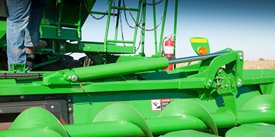 Folding cylinders
Folding cylinders
Two large folding cylinders provide smooth hydraulic force to move the corn head wings from working position to transport position.
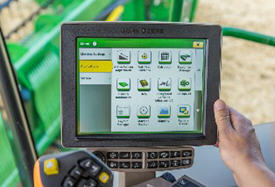 4600 CommandCenter™ display
4600 CommandCenter™ display
Folding functionality is integrated into the cab, allowing customers to quickly fold the corn head from the 4600 CommandCenter™ Display without leaving the cab.
RowMax™ stalk roll options for a variety of customer needs
Customers have asked for stalk rolls to appropriately size residue for their operation while managing power and overall header weight.
John Deere offers RowMax stalk rolls to address customer needs around residue, power, and weight for their front-end equipment.
RowMax stalk roll features and benefits:
- RowMax stalk rolls can improve wear life by 25 to 30 percent compared to the 600C base stalk rolls.
- Three stalk roll options allow customers to select the appropriate length of corn stalk residue.
- To provide high performance during harvest, RowMax stalk rolls are designed with reduced power and fuel consumption in mind.
- RowMax Chopping Stalk Roll drops stalk residue on top of the row for improved planting performance for no-till and strip-till customers the following season. Additionally, the chopping stalk roll blossoms the top of the stalk for reduced tire and track damage.
 Stalk residue dropped on top of the row
Stalk residue dropped on top of the row
 Top of the stalk is blossomed
Top of the stalk is blossomed
RowMax stalk roll details:
- The stalk rolls are manufactured from highly durable austempered ductile iron material with an added wear coating for increased wear life.
- The full-length blades provide total crop contact for appropriate sizing and cutting action from front to back.
- Stalk roll tip speed compared to gathering chain speed is optimized to reduce material-other-than-grain (MOG) intake and increase overall capacity while minimizing losses.
- Enclosed chain drives gathering chains and stalk rolls for each row to provide robust durability and uninterrupted harvesting.
- Single-piece cast knife roll design provides excellent serviceability when replacement is required.
 Row-unit
Row-unit
 Single-piece cast knife roll
Single-piece cast knife roll
Choosing the correct RowMax stalk roll
| Stalk rolls without StalkMaster™ corn heads |
RowMax Opposed | RowMax Intermeshing | RowMax Chopping |
| Knife alignment |  |
 |
 |
| Residue size | Good | Good | Better |
| Residue breakdown | Fast | Faster | Fastest |
| Soil warm up/dry down | Fast | Faster | Fastest |
| Wear life | Better | Better | Best |
| Row unit power consumption | Best | Better | Better |
| Fuel consumption | Best | Better | Good |
| Trash intake | Best | Better | Better |
| Dry stalks | Best | Good | Good |
| Wet stalks | Best | Better | Better |
| Down corn | Best | Good | Good |
| Weight for two stalk rolls | 17.2 kg (38 lb) | 18.1 kg (40 lb) | 19.5 kg (43 lb) |
| StalkMaster with RowMax opposed stalk roll | |||
| Residue size | Best | ||
| Row unit power consumption vs. opposed without StalkMaster | Good | ||
| Weight | Additional 19.1 kg (42 lb) per row for StalkMaster components | ||
| General stalk roll parts information | |||
| Number of knives | 8 | 6 | 10 |
| Aftermarket part numbers* (left hand) | HXE110671 | HXE110675 | HXE141569 |
| Aftermarket part numbers* (right hand) | HXE110672 | HXE110676 | HXE141570 |
| Compatibility | Model year 2012 and newer 600C/600FC and 700C/700FC for StalkMaster and non StalkMaster row units; factory-installed option code for model year 2020 Corn Heads |
||
*NOTE: Part numbers are subject to change. Please check the parts order before completing the transaction.
RowMax™ row-unit kit for 700C/FC and 600C/FC Corn Heads
The 700C/FC Corn Head RowMax row-unit provides customers increased durability and longer wear life. RowMax row-units include updates to gathering chains, gathering chain sprockets, chain guides, and stalk rolls. These improvements extend the life of the corn head for lower ownership cost.
Feature benefit:
- Increased wear life of row-unit gathering chains and sprockets by 50 percent due to solid alloy pin bushings and increased number of sprocket teeth
- Increased wear life of stalk rolls up to 30 percent with an improved wear coating
- Maintain corn head performance durability with an increase in stalk roll material hardness
 RowMax row-unit
RowMax row-unit
 Gathering chain and sprocket
Gathering chain and sprocket
Functionality:
To extend the life of the corn head, the RowMax row-unit increases the number of sprocket teeth on gathering chains from six teeth to eight teeth. The gathering chain has an additional 12 links and an anti-bend back feature on the chain lug. Gathering chain wear is reduced by using a solid alloy bushing.
StalkMaster™ row-unit enables a high level of stalk residue processing
 StalkMaster row-unit
StalkMaster row-unit
Available as an option, StalkMaster provides ultimate stalk sizing by processing stalks smaller than stalk rolls allowing the operator to potentially eliminate second-pass operations, saving time, fuel, labor, and additional operating costs.
Feature benefit:
- Consistent sizing of corn stalks to speed up decomposition and provide soil protection from blowing wind and water runoff
- StalkMaster can be equipped with either intermeshing, opposed, or chopping stalk rolls
- Ultimate flexibility to chop or not chop when desired through a quick, no-tools-required disconnect feature
Functionality
 StalkMaster blades
StalkMaster blades
Each StalkMaster row-unit gearcase is equipped with two heat-treated and wear-coated rotating blades positioned below the stalk rolls. The blades can be reversed to extend their wear life. These blades cut stalk to size and distribute residue evenly throughout the row. If the blades encounter an obstruction they will swing backward, avoiding damage and interruption to harvest.
 StalkMaster disconnect feature
StalkMaster disconnect feature
The StalkMaster row-unit gearcase feature a no-tools-required disconnect. Each row has a lever on the right side of the gearcase to turn the function on or off in a matter of minutes if desired, allowing for lower fuel consumption.
 StalkMaster gearcase
StalkMaster gearcase
A heavy-duty slip-clutch design protects the row-unit gearcase and the StalkMaster lower unit gearcase.
 712C right-hand side and drive shaft
712C right-hand side and drive shaft
The gathering chains and stalk rolls for each row are enclosed to provide robust durability. Heavy-duty bearings along with O-ring seals improve serviceability.
 Larger sprockets and chain
Larger sprockets and chain
A continuous-loop chain allows higher loads and longer life by eliminating all connector links and half links. The large-diameter sprockets along with a large 38-mm (1.50-in.) transverse hex back shaft and row-unit shaft provide improved sprocket and chain.
 Telescoping drive shaft
Telescoping drive shaft
A telescoping drive shaft mounts to the splined feederhouse back shaft on all 50, 60, 70, W-, T-, C-, and S-Series Combines.
The coupler features an 8-degree index, allowing the customer to match the drive shaft splines without rotating the platform feederhouse.
Telescoping drive shafts can be retrofitted to earlier 90 Series and 40 Series Corn Heads.
 Rubberized curtains
Rubberized curtains
 Steel-protective shield
Steel-protective shield
StalkMaster row units feature side- and rear-mounted rubberized curtains to optimize residue distribution. The right-hand side of the head has an additional shield to protect customers from protruding blades.
AutoTrac™ RowSense™ enables hands-free corn harvest
 Feelers keep the combine on the row
Feelers keep the combine on the row
AutoTrac RowSense, an innovative global positioning system (GPS) steering system, reduces overlap and fatigue during harvest.
Feature benefit:
- Continue harvesting in down crop and dusty conditions
- Increases acre-per-hour potential and reduce grain loss
- Enhances operator comfort while reducing stress
Functionality
 StarFire™ position receiver picks up signal
StarFire™ position receiver picks up signal
Features
RowMax™ stalk roll options for a variety of customer needs
Customers have asked for stalk rolls to appropriately size residue for their operation while managing power and overall header weight.
John Deere offers RowMax stalk rolls to address customer needs around residue, power, and weight for their front-end equipment.
RowMax stalk roll features and benefits:
- RowMax stalk rolls can improve wear life by 25 to 30 percent compared to the 600C base stalk rolls.
- Three stalk roll options allow customers to select the appropriate length of corn stalk residue.
- To provide high performance during harvest, RowMax stalk rolls are designed with reduced power and fuel consumption in mind.
- RowMax Chopping Stalk Roll drops stalk residue on top of the row for improved planting performance for no-till and strip-till customers the following season. Additionally, the chopping stalk roll blossoms the top of the stalk for reduced tire and track damage.
 Stalk residue dropped on top of the row
Stalk residue dropped on top of the row
 Top of the stalk is blossomed
Top of the stalk is blossomed
RowMax stalk roll details:
- The stalk rolls are manufactured from highly durable austempered ductile iron material with an added wear coating for increased wear life.
- The full-length blades provide total crop contact for appropriate sizing and cutting action from front to back.
- Stalk roll tip speed compared to gathering chain speed is optimized to reduce material-other-than-grain (MOG) intake and increase overall capacity while minimizing losses.
- Enclosed chain drives gathering chains and stalk rolls for each row to provide robust durability and uninterrupted harvesting.
- Single-piece cast knife roll design provides excellent serviceability when replacement is required.
 Row-unit
Row-unit
 Single-piece cast knife roll
Single-piece cast knife roll
Choosing the correct RowMax stalk roll
| Stalk rolls without StalkMaster™ corn heads |
RowMax Opposed | RowMax Intermeshing | RowMax Chopping |
| Knife alignment |  |
 |
 |
| Residue size | Good | Good | Better |
| Residue breakdown | Fast | Faster | Fastest |
| Soil warm up/dry down | Fast | Faster | Fastest |
| Wear life | Better | Better | Best |
| Row unit power consumption | Best | Better | Better |
| Fuel consumption | Best | Better | Good |
| Trash intake | Best | Better | Better |
| Dry stalks | Best | Good | Good |
| Wet stalks | Best | Better | Better |
| Down corn | Best | Good | Good |
| Weight for two stalk rolls | 17.2 kg (38 lb) | 18.1 kg (40 lb) | 19.5 kg (43 lb) |
| StalkMaster with RowMax opposed stalk roll | |||
| Residue size | Best | ||
| Row unit power consumption vs. opposed without StalkMaster | Good | ||
| Weight | Additional 19.1 kg (42 lb) per row for StalkMaster components | ||
| General stalk roll parts information | |||
| Number of knives | 8 | 6 | 10 |
| Aftermarket part numbers* (left hand) | HXE110671 | HXE110675 | HXE141569 |
| Aftermarket part numbers* (right hand) | HXE110672 | HXE110676 | HXE141570 |
| Compatibility | Model year 2012 and newer 600C/600FC and 700C/700FC for StalkMaster and non StalkMaster row units; factory-installed option code for model year 2020 Corn Heads |
||
*NOTE: Part numbers are subject to change. Please check the parts order before completing the transaction.
RowMax™ row-unit kit for 700C/FC and 600C/FC Corn Heads
The 700C/FC Corn Head RowMax row-unit provides customers increased durability and longer wear life. RowMax row-units include updates to gathering chains, gathering chain sprockets, chain guides, and stalk rolls. These improvements extend the life of the corn head for lower ownership cost.
Feature benefit:
- Increased wear life of row-unit gathering chains and sprockets by 50 percent due to solid alloy pin bushings and increased number of sprocket teeth
- Increased wear life of stalk rolls up to 30 percent with an improved wear coating
- Maintain corn head performance durability with an increase in stalk roll material hardness
 RowMax row-unit
RowMax row-unit
 Gathering chain and sprocket
Gathering chain and sprocket
Functionality:
To extend the life of the corn head, the RowMax row-unit increases the number of sprocket teeth on gathering chains from six teeth to eight teeth. The gathering chain has an additional 12 links and an anti-bend back feature on the chain lug. Gathering chain wear is reduced by using a solid alloy bushing.
StalkMaster™ row-unit enables a high level of stalk residue processing
 StalkMaster row-unit
StalkMaster row-unit
Available as an option, StalkMaster provides ultimate stalk sizing by processing stalks smaller than stalk rolls allowing the operator to potentially eliminate second-pass operations, saving time, fuel, labor, and additional operating costs.
Feature benefit:
- Consistent sizing of corn stalks to speed up decomposition and provide soil protection from blowing wind and water runoff
- StalkMaster can be equipped with either intermeshing, opposed, or chopping stalk rolls
- Ultimate flexibility to chop or not chop when desired through a quick, no-tools-required disconnect feature
Functionality
 StalkMaster blades
StalkMaster blades
Each StalkMaster row-unit gearcase is equipped with two heat-treated and wear-coated rotating blades positioned below the stalk rolls. The blades can be reversed to extend their wear life. These blades cut stalk to size and distribute residue evenly throughout the row. If the blades encounter an obstruction they will swing backward, avoiding damage and interruption to harvest.
 StalkMaster disconnect feature
StalkMaster disconnect feature
The StalkMaster row-unit gearcase feature a no-tools-required disconnect. Each row has a lever on the right side of the gearcase to turn the function on or off in a matter of minutes if desired, allowing for lower fuel consumption.
 StalkMaster gearcase
StalkMaster gearcase
A heavy-duty slip-clutch design protects the row-unit gearcase and the StalkMaster lower unit gearcase.
 712C right-hand side and drive shaft
712C right-hand side and drive shaft
The gathering chains and stalk rolls for each row are enclosed to provide robust durability. Heavy-duty bearings along with O-ring seals improve serviceability.
 Larger sprockets and chain
Larger sprockets and chain
A continuous-loop chain allows higher loads and longer life by eliminating all connector links and half links. The large-diameter sprockets along with a large 38-mm (1.50-in.) transverse hex back shaft and row-unit shaft provide improved sprocket and chain.
 Telescoping drive shaft
Telescoping drive shaft
A telescoping drive shaft mounts to the splined feederhouse back shaft on all 50, 60, 70, W-, T-, C-, and S-Series Combines.
The coupler features an 8-degree index, allowing the customer to match the drive shaft splines without rotating the platform feederhouse.
Telescoping drive shafts can be retrofitted to earlier 90 Series and 40 Series Corn Heads.
 Rubberized curtains
Rubberized curtains
 Steel-protective shield
Steel-protective shield
StalkMaster row units feature side- and rear-mounted rubberized curtains to optimize residue distribution. The right-hand side of the head has an additional shield to protect customers from protruding blades.
AutoTrac™ RowSense™ enables hands-free corn harvest
 Feelers keep the combine on the row
Feelers keep the combine on the row
AutoTrac RowSense, an innovative global positioning system (GPS) steering system, reduces overlap and fatigue during harvest.
Feature benefit:
- Continue harvesting in down crop and dusty conditions
- Increases acre-per-hour potential and reduce grain loss
- Enhances operator comfort while reducing stress
Functionality
 StarFire™ position receiver picks up signal
StarFire™ position receiver picks up signal
Features
Folding capability simplifies moving between fields during harvest
Folding corn heads perform exceptionally well at higher harvesting speeds while providing narrow transport widths when attached to the combine, which means operators can finish faster.
Feature benefit:
- The 700FC reduces cost of operation by eliminating the need to purchase a header trailer to transport corn heads between fields during harvest.
- Eliminates the time needed to mount the header to a trailer and reattach it to the combine at the next field.
- Reduces the space needed to store the corn head.
Theory of operation:
 Folding cylinders
Folding cylinders
Two large folding cylinders provide smooth hydraulic force to move the corn head wings from working position to transport position.
 4600 CommandCenter™ display
4600 CommandCenter™ display
Folding functionality is integrated into the cab, allowing customers to quickly fold the corn head from the 4600 CommandCenter™ Display without leaving the cab.
RowMax™ stalk roll options for a variety of customer needs
Customers have asked for stalk rolls to appropriately size residue for their operation while managing power and overall header weight.
John Deere offers RowMax stalk rolls to address customer needs around residue, power, and weight for their front-end equipment.
RowMax stalk roll features and benefits:
- RowMax stalk rolls can improve wear life by 25 to 30 percent compared to the 600C base stalk rolls.
- Three stalk roll options allow customers to select the appropriate length of corn stalk residue.
- To provide high performance during harvest, RowMax stalk rolls are designed with reduced power and fuel consumption in mind.
- RowMax Chopping Stalk Roll drops stalk residue on top of the row for improved planting performance for no-till and strip-till customers the following season. Additionally, the chopping stalk roll blossoms the top of the stalk for reduced tire and track damage.
 Stalk residue dropped on top of the row
Stalk residue dropped on top of the row
 Top of the stalk is blossomed
Top of the stalk is blossomed
RowMax stalk roll details:
- The stalk rolls are manufactured from highly durable austempered ductile iron material with an added wear coating for increased wear life.
- The full-length blades provide total crop contact for appropriate sizing and cutting action from front to back.
- Stalk roll tip speed compared to gathering chain speed is optimized to reduce material-other-than-grain (MOG) intake and increase overall capacity while minimizing losses.
- Enclosed chain drives gathering chains and stalk rolls for each row to provide robust durability and uninterrupted harvesting.
- Single-piece cast knife roll design provides excellent serviceability when replacement is required.
 Row-unit
Row-unit
 Single-piece cast knife roll
Single-piece cast knife roll
Choosing the correct RowMax stalk roll
| Stalk rolls without StalkMaster™ corn heads |
RowMax Opposed | RowMax Intermeshing | RowMax Chopping |
| Knife alignment |  |
 |
 |
| Residue size | Good | Good | Better |
| Residue breakdown | Fast | Faster | Fastest |
| Soil warm up/dry down | Fast | Faster | Fastest |
| Wear life | Better | Better | Best |
| Row unit power consumption | Best | Better | Better |
| Fuel consumption | Best | Better | Good |
| Trash intake | Best | Better | Better |
| Dry stalks | Best | Good | Good |
| Wet stalks | Best | Better | Better |
| Down corn | Best | Good | Good |
| Weight for two stalk rolls | 17.2 kg (38 lb) | 18.1 kg (40 lb) | 19.5 kg (43 lb) |
| StalkMaster with RowMax opposed stalk roll | |||
| Residue size | Best | ||
| Row unit power consumption vs. opposed without StalkMaster | Good | ||
| Weight | Additional 19.1 kg (42 lb) per row for StalkMaster components | ||
| General stalk roll parts information | |||
| Number of knives | 8 | 6 | 10 |
| Aftermarket part numbers* (left hand) | HXE110671 | HXE110675 | HXE141569 |
| Aftermarket part numbers* (right hand) | HXE110672 | HXE110676 | HXE141570 |
| Compatibility | Model year 2012 and newer 600C/600FC and 700C/700FC for StalkMaster and non StalkMaster row units; factory-installed option code for model year 2020 Corn Heads |
||
*NOTE: Part numbers are subject to change. Please check the parts order before completing the transaction.
RowMax™ row-unit kit for 700C/FC and 600C/FC Corn Heads
The 700C/FC Corn Head RowMax row-unit provides customers increased durability and longer wear life. RowMax row-units include updates to gathering chains, gathering chain sprockets, chain guides, and stalk rolls. These improvements extend the life of the corn head for lower ownership cost.
Feature benefit:
- Increased wear life of row-unit gathering chains and sprockets by 50 percent due to solid alloy pin bushings and increased number of sprocket teeth
- Increased wear life of stalk rolls up to 30 percent with an improved wear coating
- Maintain corn head performance durability with an increase in stalk roll material hardness
 RowMax row-unit
RowMax row-unit
 Gathering chain and sprocket
Gathering chain and sprocket
Functionality:
To extend the life of the corn head, the RowMax row-unit increases the number of sprocket teeth on gathering chains from six teeth to eight teeth. The gathering chain has an additional 12 links and an anti-bend back feature on the chain lug. Gathering chain wear is reduced by using a solid alloy bushing.
StalkMaster™ row-unit enables a high level of stalk residue processing
 StalkMaster row-unit
StalkMaster row-unit
Available as an option, StalkMaster provides ultimate stalk sizing by processing stalks smaller than stalk rolls allowing the operator to potentially eliminate second-pass operations, saving time, fuel, labor, and additional operating costs.
Feature benefit:
- Consistent sizing of corn stalks to speed up decomposition and provide soil protection from blowing wind and water runoff
- StalkMaster can be equipped with either intermeshing, opposed, or chopping stalk rolls
- Ultimate flexibility to chop or not chop when desired through a quick, no-tools-required disconnect feature
Functionality
 StalkMaster blades
StalkMaster blades
Each StalkMaster row-unit gearcase is equipped with two heat-treated and wear-coated rotating blades positioned below the stalk rolls. The blades can be reversed to extend their wear life. These blades cut stalk to size and distribute residue evenly throughout the row. If the blades encounter an obstruction they will swing backward, avoiding damage and interruption to harvest.
 StalkMaster disconnect feature
StalkMaster disconnect feature
The StalkMaster row-unit gearcase feature a no-tools-required disconnect. Each row has a lever on the right side of the gearcase to turn the function on or off in a matter of minutes if desired, allowing for lower fuel consumption.
 StalkMaster gearcase
StalkMaster gearcase
A heavy-duty slip-clutch design protects the row-unit gearcase and the StalkMaster lower unit gearcase.
 712C right-hand side and drive shaft
712C right-hand side and drive shaft
The gathering chains and stalk rolls for each row are enclosed to provide robust durability. Heavy-duty bearings along with O-ring seals improve serviceability.
 Larger sprockets and chain
Larger sprockets and chain
A continuous-loop chain allows higher loads and longer life by eliminating all connector links and half links. The large-diameter sprockets along with a large 38-mm (1.50-in.) transverse hex back shaft and row-unit shaft provide improved sprocket and chain.
 Telescoping drive shaft
Telescoping drive shaft
A telescoping drive shaft mounts to the splined feederhouse back shaft on all 50, 60, 70, W-, T-, C-, and S-Series Combines.
The coupler features an 8-degree index, allowing the customer to match the drive shaft splines without rotating the platform feederhouse.
Telescoping drive shafts can be retrofitted to earlier 90 Series and 40 Series Corn Heads.
 Rubberized curtains
Rubberized curtains
 Steel-protective shield
Steel-protective shield
StalkMaster row units feature side- and rear-mounted rubberized curtains to optimize residue distribution. The right-hand side of the head has an additional shield to protect customers from protruding blades.
AutoTrac™ RowSense™ enables hands-free corn harvest
 Feelers keep the combine on the row
Feelers keep the combine on the row
AutoTrac RowSense, an innovative global positioning system (GPS) steering system, reduces overlap and fatigue during harvest.
Feature benefit:
- Continue harvesting in down crop and dusty conditions
- Increases acre-per-hour potential and reduce grain loss
- Enhances operator comfort while reducing stress
Functionality
 StarFire™ position receiver picks up signal
StarFire™ position receiver picks up signal
Features
RowMax™ stalk roll options for a variety of customer needs
Customers have asked for stalk rolls to appropriately size residue for their operation while managing power and overall header weight.
John Deere offers RowMax stalk rolls to address customer needs around residue, power, and weight for their front-end equipment.
RowMax stalk roll features and benefits:
- RowMax stalk rolls can improve wear life by 25 to 30 percent compared to the 600C base stalk rolls.
- Three stalk roll options allow customers to select the appropriate length of corn stalk residue.
- To provide high performance during harvest, RowMax stalk rolls are designed with reduced power and fuel consumption in mind.
- RowMax Chopping Stalk Roll drops stalk residue on top of the row for improved planting performance for no-till and strip-till customers the following season. Additionally, the chopping stalk roll blossoms the top of the stalk for reduced tire and track damage.
 Stalk residue dropped on top of the row
Stalk residue dropped on top of the row
 Top of the stalk is blossomed
Top of the stalk is blossomed
RowMax stalk roll details:
- The stalk rolls are manufactured from highly durable austempered ductile iron material with an added wear coating for increased wear life.
- The full-length blades provide total crop contact for appropriate sizing and cutting action from front to back.
- Stalk roll tip speed compared to gathering chain speed is optimized to reduce material-other-than-grain (MOG) intake and increase overall capacity while minimizing losses.
- Enclosed chain drives gathering chains and stalk rolls for each row to provide robust durability and uninterrupted harvesting.
- Single-piece cast knife roll design provides excellent serviceability when replacement is required.
 Row-unit
Row-unit
 Single-piece cast knife roll
Single-piece cast knife roll
Choosing the correct RowMax stalk roll
| Stalk rolls without StalkMaster™ corn heads |
RowMax Opposed | RowMax Intermeshing | RowMax Chopping |
| Knife alignment |  |
 |
 |
| Residue size | Good | Good | Better |
| Residue breakdown | Fast | Faster | Fastest |
| Soil warm up/dry down | Fast | Faster | Fastest |
| Wear life | Better | Better | Best |
| Row unit power consumption | Best | Better | Better |
| Fuel consumption | Best | Better | Good |
| Trash intake | Best | Better | Better |
| Dry stalks | Best | Good | Good |
| Wet stalks | Best | Better | Better |
| Down corn | Best | Good | Good |
| Weight for two stalk rolls | 17.2 kg (38 lb) | 18.1 kg (40 lb) | 19.5 kg (43 lb) |
| StalkMaster with RowMax opposed stalk roll | |||
| Residue size | Best | ||
| Row unit power consumption vs. opposed without StalkMaster | Good | ||
| Weight | Additional 19.1 kg (42 lb) per row for StalkMaster components | ||
| General stalk roll parts information | |||
| Number of knives | 8 | 6 | 10 |
| Aftermarket part numbers* (left hand) | HXE110671 | HXE110675 | HXE141569 |
| Aftermarket part numbers* (right hand) | HXE110672 | HXE110676 | HXE141570 |
| Compatibility | Model year 2012 and newer 600C/600FC and 700C/700FC for StalkMaster and non StalkMaster row units; factory-installed option code for model year 2020 Corn Heads |
||
*NOTE: Part numbers are subject to change. Please check the parts order before completing the transaction.
RowMax™ row-unit kit for 700C/FC and 600C/FC Corn Heads
The 700C/FC Corn Head RowMax row-unit provides customers increased durability and longer wear life. RowMax row-units include updates to gathering chains, gathering chain sprockets, chain guides, and stalk rolls. These improvements extend the life of the corn head for lower ownership cost.
Feature benefit:
- Increased wear life of row-unit gathering chains and sprockets by 50 percent due to solid alloy pin bushings and increased number of sprocket teeth
- Increased wear life of stalk rolls up to 30 percent with an improved wear coating
- Maintain corn head performance durability with an increase in stalk roll material hardness
 RowMax row-unit
RowMax row-unit
 Gathering chain and sprocket
Gathering chain and sprocket
Functionality:
To extend the life of the corn head, the RowMax row-unit increases the number of sprocket teeth on gathering chains from six teeth to eight teeth. The gathering chain has an additional 12 links and an anti-bend back feature on the chain lug. Gathering chain wear is reduced by using a solid alloy bushing.
StalkMaster™ row-unit enables a high level of stalk residue processing
 StalkMaster row-unit
StalkMaster row-unit
Available as an option, StalkMaster provides ultimate stalk sizing by processing stalks smaller than stalk rolls allowing the operator to potentially eliminate second-pass operations, saving time, fuel, labor, and additional operating costs.
Feature benefit:
- Consistent sizing of corn stalks to speed up decomposition and provide soil protection from blowing wind and water runoff
- StalkMaster can be equipped with either intermeshing, opposed, or chopping stalk rolls
- Ultimate flexibility to chop or not chop when desired through a quick, no-tools-required disconnect feature
Functionality
 StalkMaster blades
StalkMaster blades
Each StalkMaster row-unit gearcase is equipped with two heat-treated and wear-coated rotating blades positioned below the stalk rolls. The blades can be reversed to extend their wear life. These blades cut stalk to size and distribute residue evenly throughout the row. If the blades encounter an obstruction they will swing backward, avoiding damage and interruption to harvest.
 StalkMaster disconnect feature
StalkMaster disconnect feature
The StalkMaster row-unit gearcase feature a no-tools-required disconnect. Each row has a lever on the right side of the gearcase to turn the function on or off in a matter of minutes if desired, allowing for lower fuel consumption.
 StalkMaster gearcase
StalkMaster gearcase
A heavy-duty slip-clutch design protects the row-unit gearcase and the StalkMaster lower unit gearcase.
 712C right-hand side and drive shaft
712C right-hand side and drive shaft
The gathering chains and stalk rolls for each row are enclosed to provide robust durability. Heavy-duty bearings along with O-ring seals improve serviceability.
 Larger sprockets and chain
Larger sprockets and chain
A continuous-loop chain allows higher loads and longer life by eliminating all connector links and half links. The large-diameter sprockets along with a large 38-mm (1.50-in.) transverse hex back shaft and row-unit shaft provide improved sprocket and chain.
 Telescoping drive shaft
Telescoping drive shaft
A telescoping drive shaft mounts to the splined feederhouse back shaft on all 50, 60, 70, W-, T-, C-, and S-Series Combines.
The coupler features an 8-degree index, allowing the customer to match the drive shaft splines without rotating the platform feederhouse.
Telescoping drive shafts can be retrofitted to earlier 90 Series and 40 Series Corn Heads.
 Rubberized curtains
Rubberized curtains
 Steel-protective shield
Steel-protective shield
StalkMaster row units feature side- and rear-mounted rubberized curtains to optimize residue distribution. The right-hand side of the head has an additional shield to protect customers from protruding blades.
AutoTrac™ RowSense™ enables hands-free corn harvest
 Feelers keep the combine on the row
Feelers keep the combine on the row
AutoTrac RowSense, an innovative global positioning system (GPS) steering system, reduces overlap and fatigue during harvest.
Feature benefit:
- Continue harvesting in down crop and dusty conditions
- Increases acre-per-hour potential and reduce grain loss
- Enhances operator comfort while reducing stress
Functionality
 StarFire™ position receiver picks up signal
StarFire™ position receiver picks up signal
Features
RowMax™ stalk roll options for a variety of customer needs
Customers have asked for stalk rolls to appropriately size residue for their operation while managing power and overall header weight.
John Deere offers RowMax stalk rolls to address customer needs around residue, power, and weight for their front-end equipment.
RowMax stalk roll features and benefits:
- RowMax stalk rolls can improve wear life by 25 to 30 percent compared to the 600C base stalk rolls.
- Three stalk roll options allow customers to select the appropriate length of corn stalk residue.
- To provide high performance during harvest, RowMax stalk rolls are designed with reduced power and fuel consumption in mind.
- RowMax Chopping Stalk Roll drops stalk residue on top of the row for improved planting performance for no-till and strip-till customers the following season. Additionally, the chopping stalk roll blossoms the top of the stalk for reduced tire and track damage.
 Stalk residue dropped on top of the row
Stalk residue dropped on top of the row
 Top of the stalk is blossomed
Top of the stalk is blossomed
RowMax stalk roll details:
- The stalk rolls are manufactured from highly durable austempered ductile iron material with an added wear coating for increased wear life.
- The full-length blades provide total crop contact for appropriate sizing and cutting action from front to back.
- Stalk roll tip speed compared to gathering chain speed is optimized to reduce material-other-than-grain (MOG) intake and increase overall capacity while minimizing losses.
- Enclosed chain drives gathering chains and stalk rolls for each row to provide robust durability and uninterrupted harvesting.
- Single-piece cast knife roll design provides excellent serviceability when replacement is required.
 Row-unit
Row-unit
 Single-piece cast knife roll
Single-piece cast knife roll
Choosing the correct RowMax stalk roll
| Stalk rolls without StalkMaster™ corn heads |
RowMax Opposed | RowMax Intermeshing | RowMax Chopping |
| Knife alignment |  |
 |
 |
| Residue size | Good | Good | Better |
| Residue breakdown | Fast | Faster | Fastest |
| Soil warm up/dry down | Fast | Faster | Fastest |
| Wear life | Better | Better | Best |
| Row unit power consumption | Best | Better | Better |
| Fuel consumption | Best | Better | Good |
| Trash intake | Best | Better | Better |
| Dry stalks | Best | Good | Good |
| Wet stalks | Best | Better | Better |
| Down corn | Best | Good | Good |
| Weight for two stalk rolls | 17.2 kg (38 lb) | 18.1 kg (40 lb) | 19.5 kg (43 lb) |
| StalkMaster with RowMax opposed stalk roll | |||
| Residue size | Best | ||
| Row unit power consumption vs. opposed without StalkMaster | Good | ||
| Weight | Additional 19.1 kg (42 lb) per row for StalkMaster components | ||
| General stalk roll parts information | |||
| Number of knives | 8 | 6 | 10 |
| Aftermarket part numbers* (left hand) | HXE110671 | HXE110675 | HXE141569 |
| Aftermarket part numbers* (right hand) | HXE110672 | HXE110676 | HXE141570 |
| Compatibility | Model year 2012 and newer 600C/600FC and 700C/700FC for StalkMaster and non StalkMaster row units; factory-installed option code for model year 2020 Corn Heads |
||
*NOTE: Part numbers are subject to change. Please check the parts order before completing the transaction.
RowMax™ row-unit kit for 700C/FC and 600C/FC Corn Heads
The 700C/FC Corn Head RowMax row-unit provides customers increased durability and longer wear life. RowMax row-units include updates to gathering chains, gathering chain sprockets, chain guides, and stalk rolls. These improvements extend the life of the corn head for lower ownership cost.
Feature benefit:
- Increased wear life of row-unit gathering chains and sprockets by 50 percent due to solid alloy pin bushings and increased number of sprocket teeth
- Increased wear life of stalk rolls up to 30 percent with an improved wear coating
- Maintain corn head performance durability with an increase in stalk roll material hardness
 RowMax row-unit
RowMax row-unit
 Gathering chain and sprocket
Gathering chain and sprocket
Functionality:
To extend the life of the corn head, the RowMax row-unit increases the number of sprocket teeth on gathering chains from six teeth to eight teeth. The gathering chain has an additional 12 links and an anti-bend back feature on the chain lug. Gathering chain wear is reduced by using a solid alloy bushing.
StalkMaster™ row-unit enables a high level of stalk residue processing
 StalkMaster row-unit
StalkMaster row-unit
Available as an option, StalkMaster provides ultimate stalk sizing by processing stalks smaller than stalk rolls allowing the operator to potentially eliminate second-pass operations, saving time, fuel, labor, and additional operating costs.
Feature benefit:
- Consistent sizing of corn stalks to speed up decomposition and provide soil protection from blowing wind and water runoff
- StalkMaster can be equipped with either intermeshing, opposed, or chopping stalk rolls
- Ultimate flexibility to chop or not chop when desired through a quick, no-tools-required disconnect feature
Functionality
 StalkMaster blades
StalkMaster blades
Each StalkMaster row-unit gearcase is equipped with two heat-treated and wear-coated rotating blades positioned below the stalk rolls. The blades can be reversed to extend their wear life. These blades cut stalk to size and distribute residue evenly throughout the row. If the blades encounter an obstruction they will swing backward, avoiding damage and interruption to harvest.
 StalkMaster disconnect feature
StalkMaster disconnect feature
The StalkMaster row-unit gearcase feature a no-tools-required disconnect. Each row has a lever on the right side of the gearcase to turn the function on or off in a matter of minutes if desired, allowing for lower fuel consumption.
 StalkMaster gearcase
StalkMaster gearcase
A heavy-duty slip-clutch design protects the row-unit gearcase and the StalkMaster lower unit gearcase.
 712C right-hand side and drive shaft
712C right-hand side and drive shaft
The gathering chains and stalk rolls for each row are enclosed to provide robust durability. Heavy-duty bearings along with O-ring seals improve serviceability.
 Larger sprockets and chain
Larger sprockets and chain
A continuous-loop chain allows higher loads and longer life by eliminating all connector links and half links. The large-diameter sprockets along with a large 38-mm (1.50-in.) transverse hex back shaft and row-unit shaft provide improved sprocket and chain.
 Telescoping drive shaft
Telescoping drive shaft
A telescoping drive shaft mounts to the splined feederhouse back shaft on all 50, 60, 70, W-, T-, C-, and S-Series Combines.
The coupler features an 8-degree index, allowing the customer to match the drive shaft splines without rotating the platform feederhouse.
Telescoping drive shafts can be retrofitted to earlier 90 Series and 40 Series Corn Heads.
 Rubberized curtains
Rubberized curtains
 Steel-protective shield
Steel-protective shield
StalkMaster row units feature side- and rear-mounted rubberized curtains to optimize residue distribution. The right-hand side of the head has an additional shield to protect customers from protruding blades.
AutoTrac™ RowSense™ enables hands-free corn harvest
 Feelers keep the combine on the row
Feelers keep the combine on the row
AutoTrac RowSense, an innovative global positioning system (GPS) steering system, reduces overlap and fatigue during harvest.
Feature benefit:
- Continue harvesting in down crop and dusty conditions
- Increases acre-per-hour potential and reduce grain loss
- Enhances operator comfort while reducing stress
Functionality
 StarFire™ position receiver picks up signal
StarFire™ position receiver picks up signal
Features
Threshing and separating concept
 Threshing and separation concept of T-Series
Threshing and separation concept of T-Series

Functional components:
- Large, 660-mm (26-in.) diameter threshing cylinder with 10 rasp bars and increased concave area
- Smooth stripper roll and enlarged overshot beater
- Enlarged, 800-mm (31.5-in.) separator with high-performance separation grate
- Eight-wing, 400-mm (15.7-in.) rear beater and rear beater grate
- Seven-step straw walker design with welded or optional bolted universal and corn-cob mix (CCM) grids
- Sectional concave with quick adjustable de-awning plates
Large, 660-mm (26-in.) threshing cylinder with 10 rasp bars and enlarged concave
The large, 10-rasp bar threshing cylinder with 660-mm (26-in.) diameter provides excellent grain quality and gentle material handling.
Combined with the enlarged wrapping angle of 124 degrees, this ensures excellent threshing efficiency, providing unmatched capacity even in tough separating conditions.
Four rasp bars are in constant contact with the crop against the concave area for excellent threshing and separating efficiency:
- Provides a large concave area and allows a slow cylinder speed
- Ensures gentle threshing and separation to reduce grain damage
- Large, concave wrapping angle ensures high grain separation right at the beginning and reduces separation load on the straw walkers
- Wide, 1670-mm (65.7-in.) (6-Walker) channel width grants maximum throughput even in tough separating conditions
Stripper drum and overshot beater
 Stripper drum
Stripper drum
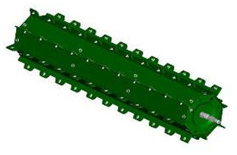 Overshot beater
Overshot beater
The T-Series threshing system uses a smooth surface stripper roller behind the threshing cylinder to gently direct the material to the overshot beater. This prevents material from back feeding on the threshing cylinder, eliminating blockages of the cylinder. The stripper roller speed runs at 125 percent ratio of the threshing cylinder speed.
The 500-mm (19.7-in.) overshot beater on the T-Series continues the material flow process. Material travels over the top of the beater and is directed into the separation drum.
Smooth crop flow is achieved without harsh angles or abrupt changes in direction.
The eight-wing beater has a constant speed. The serrated design of the wings’ leading edges engage the mat of material and move the high volumes of tough, damp straw without buildup or bunching.
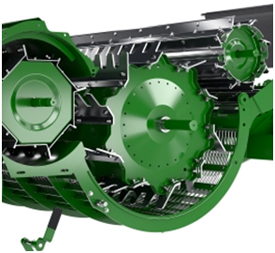 Extra-large separator and dynamic tangential grate
Extra-large separator and dynamic tangential grate
The 800-mm (31.5-in.) extra-large separator drum provides additional separation capacity or the T-Series. Due to the open design, the drum is not heavier in weight than the previous closed design.
The extra-large separator drum runs at two factory-installed speeds:
- 760 rpm for small grain and grass seed
- 380 rpm for canola, peas, and beans
There is an optional 270 rpm speed reduction kit available for corn harvest which is included in the corn package. Swapping the belt speed can be done easily and quickly by changing the drive pulley via a lever-operated tension pulley.
The extra-large separator drum runs at a lower speed compared to the previous design that was operated at 900/450 rpm. While it seems that higher drum speeds result in more efficient separation capacity caused by the higher centrifugal force, the opposite effect has been measured. While the centrifugal force has a vital impact on the separation capacity, speeds of the separator drum that are too high result in low exposure time in the high-performance separator grate. This is shown in the graph below.
Comparison of separator speed
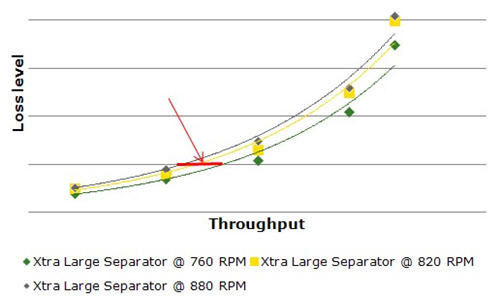 Comparison separator speed
Comparison separator speed

The red line indicates the performance delta at a loss level of one percent between the different separator speeds.
The dynamic tangential grate (new beginning in model year 2019) features a completely updated design equipped with a full wire profile as described below.
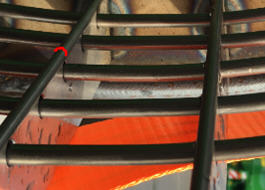 Dynamic tangential grate
Dynamic tangential grate
For model year 2019, the design was changed for fewer restrictions on crop flow and optimal separation that would not affect straw quality.
- All the transversal bars are produced with round edges for better crop flow and straw quality.
- All the wires are repositioned as close to the upper edge as possible to prevent any straw accumulation, therefore improving separation capacity.
- The wires are implemented on the complete area and replace finger rakes for larger opening areas (+10 percent opening area versus model year 2016 tangential grate).
Rear beater and rear beater grate
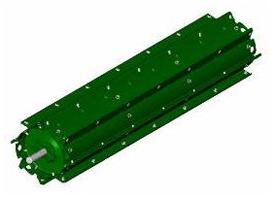 Rear beater
Rear beater

The 400-mm (15.7-in.) rear beater on the T-Series continues the material flow process. The beater delivers material to the straw walkers. The beater is driven directly from the extra-large separator drum and is operated at two speeds.
- 900 rpm for small grain and grass seed
- 450 rpm for rape seed, corn, peas, and beans
A separation grate is mounted underneath the rear beater. The grate is adjustable with a handle on the right side.
Two positions are available:
- Wide position recommended in rape seed, corn, peas, beans, or other sensitive crops
- Narrow position for small grain or grass seed
Inside the T-Series threshing and separation system is an eight-winged, rear beater drum that separates the remaining grain out of the straw mat. The rear beater grate provides additional active separation area.
Straw walker concept
 Seven-step straw walker design
Seven-step straw walker design

The T-Series has a seven-step straw walker concept. Compared to the previous T-Series, the model year 2017 and newer T-Series straw walker is extended by 80 mm (3.15 in.), which results in a slightly increased overall straw walker area (+ 0.1 m² [1.08 sq ft]). The concept of low walker rpm and high walker stroke provides efficient tossing to fluff even largest straw mats and open channels for the free grains to drop through. This results in most efficient grain separation capability. The straw walker is available with welded or bolted universal and CCM grids for best-in-class reconfiguration and ability to retrofit for all crops and conditions.
The straw walker is equipped with a closed walker trough at the rear, which ensures the grain is captured in the trough and feeds evenly on the walker return pan that is mounted below the front section of the walkers. Section dividers on the return pan help to maintain an even distribution of material onto the front chaffer of the cleaning system, even on slopes.
- High throw provides efficient tossing to fluff even the largest straw mats and open channels for the kernels to drop through.
- Maximum grain separation is achieved at the front section due to the impact of the straw mat when hitting the first walker steps.
- Four shallow, angled steps provide maximum separating efficiency.
Different walker grids are available to match all crop and conditions.
Overall threshing and separation system benefits:
- Greater level of productivity due to the enlarged concave wrapping angle, extra-large separator drum, and the high-performance separator grate
- Best-in-class grain and straw quality can be achieved with the threshing and separating concept
- Fast and easy adoption for different crops
- Lower power consumption and excellent straw quality, making this combine the optimal choice for straw producers
Sectional concave with quick adjustable de-awning plates
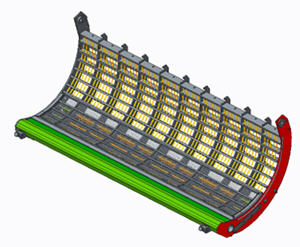 Sectional concave with small-grain inserts
Sectional concave with small-grain inserts
Feature benefits:
- High versatility and flexibility with three different concave inserts available
- Uptime ensured with fast exchange design
- Easy access from stone trap and storage position for the concave inserts
Theory of operation
Versatility on a combine is increasingly important as producers have to handle multiple crops, sometimes changing between crops during the day.
The threshing needs are very different from crop to crop. Coarse grains like corn or peas require a round bar profile that is less aggressive to ensure optimal grain quality. Small grains including grass seed, vegetables seeds, and durum wheat need intensive threshing and require a small-grain concave profile which provides aggressive threshing to separate the grain.
The sectional concave is made with a fixed concave associated to a removable design on the front where the threshing begins.
Producers will have the possibility to install three different concave profiles:
- Small-grain concave inserts
- Universal concave inserts
- Round-bar concave inserts
- Sectional concave with round-bar concave inserts
Producers can exchange the concave inserts in 15 to 20 minutes by opening the stone trap.
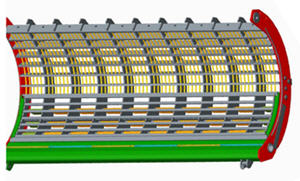
A screw is available on the left side and will maintain the concave inserts in the working position. When the operator loosens the screw, he can easily remove the two inserts and replace them with another set of inserts.
On the right side, the operator has the capability via a screw to install or remove the swing in/out booster bar.
The machine will be delivered with small-grain inserts installed and can receive additional universal inserts as factory installed (in storage) or round-bar inserts as dealer installed.
More cleaning system capacity with the Dyna-Flo™ Plus cleaning shoe
 Remote adjustment of Dyna-Flo Plus cleaning system
Remote adjustment of Dyna-Flo Plus cleaning system

The Dyna-Flo Plus cleaning system comes standard with electric adjustment on all T670 Combines.
The remote cleaning shoe adjustment can be either completed from inside the cab on display settings or with the armrest buttons. As an alternative solution, such as when inspecting the shoe from the outside, settings can also be adjusted from the left side at the rear of the machine.
The remote cleaning shoe adjustment motors are equipped with an integrated position sensor. This eliminates the need for recalibration of the electric motors. Calibrations only need to be redone in case the electric hardware or the cleaning shoe elements get replaced.
4813 |
Remote cleaning shoe adjustment
Dyna-Flo Plus cleaning shoe |
Corn package
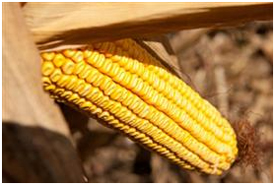 Corn harvest
Corn harvest
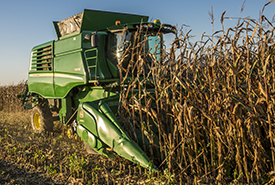 Corn harvest
Corn harvest
When harvesting corn grain, quality is key. The threshing and separating process must be done extremely gently and all crop-engaging components must be operated at lower speeds. The corn package includes a wide range of speed reduction components such as the 15/33 feederhouse speed-reduction sprocket and T-separator speed reduction, which guarantees excellent grain quality even under dry conditions.
A brush sealing kit comes installed on the side panels around the cleaning shoe fan air inlet. This prevents corn leaves from being sucked into the cleaning shoe where they potentially can plug the louvers and cause insufficient cleaning shoe performance resulting in dirty grain tank samples or high grain losses.
The dual-range cylinder drive must be ordered in combination with the corn package and is dealer-installed.
Drive parts to slow down the unloading auger come by-packed and are especially recommended in high-moisture corn harvest (more than 32 percent moisture) to reduce the risk of unloading auger blockage or premature shear bolt failure. For dry corn harvest (below 32 percent moisture), the unloading rate can be reduced by adjusting the grain tank cross auger covers to a lower position (please refer to the operator’s manual).
To avoid damage on the straw chopper, the dual-range chopper drive must be ordered in combination with the corn package and is dealer-installed. To avoid further damage at the chopper housing and the straw hood, a cob deflector plus stationary knife cover comes by-packed with the machine.
To prevent damage on the chaff spreader disk or housing, a speed reduction valve comes installed when the corn package is ordered. This reduces the chaff spreader speed.
Option code |
Description |
4211 |
Corn package NOTE: Requires dual-range cylinder drive – code 4420. NOTE: Requires dual-speed straw chopper drive – code 8570. |
The clean-grain elevator can be equipped with stainless-steel paddles for reliable clean-grain transportation and a slip clutch to prevent blockage inside the housing or elevator chain/drive belt damage due to the higher amount of grain. This slip clutch is strongly recommended in wet harvesting conditions (above 32 percent grain moisture) and needs to be ordered separately.
Option code |
Description |
8526 |
Clean-grain elevator slip clutch |
Factory installed:
- Dual-range cylinder drive
- Dual-speed chopper drive
- Chaff spreader speed reduction valve
By-packed:
- Feederhouse speed reduction sprocket 15/33
- Stone trap cover plate
- Cylinder filling plates
- Unloading auger speed reduction sprockets
- Cleaning shoe fan air inlet brush kit
- Corn cob deflector for rear hood (fine-cut and extra-fine cut chopper)
- Counter knife cover (fine-cut and extra-fine cut chopper)
- Extra-large separator speed reduction (T-Series only)
NOTE: Code 8526 clean grain elevator slip clutch is highly recommended for wet corn harvest (more than 32 percent moisture) – not included in corn package.
Pre-selection when corn package is ordered:
- Dual-speed cylinder drive (code 4420)
- Dual-speed chopper drive (code 8570)
To ensure excellent cleaning shoe performance of the Dyna-Flo™ Plus cleaning system, a wide range of cleaning shoe elements are offered that are specially designed for corn harvest.
The premium corn cleaning shoe elements ensure excellent cleaning shoe performance in dry or medium moisture conditions, which results in excellent grain tank quality. In high-moisture conditions, they avoid plug-in of louver elements, which ensures the machine keeps harvesting and eliminates the need for the operator to stop the machine and clean the chaffer elements to avoid excessive grain losses.
The corn cob mix (CCM) frog-mouth elements provide a wide 80-mm (3.1-in.) opening, enabling a big portion of the cobs to pass the chaffer element and be collected in the grain tank.
The tailings cover kit is required when the machine is operated without a lower sieve.
Grass package for walker combines
 Grass seed
Grass seed
 Grass field
Grass field
Harvesting grass seed requires optimum air flow distribution resulting in excellent cleaning shoe performance as the very light grass seeds are extremely sensitive to uneven air flow. This causes either losses by being blown out the back or shaken out in case they come in direct contact with the louver elements.
The grass package must be ordered with the dual-range fan drive that reduces the fan speed range down to 300 rpm, which is zero to none especially for extremely light seed varieties such as grass seed.
To ensure optimum grain handling, the grass package must be ordered with the grain elevator slip clutch, including steel paddles. The steel paddles whip out the elevator housing and ensure crop does not accumulate, especially when doing straight-cut grass harvest where moisture might be higher. The grain elevator slip clutch avoids premature belt or drive component failure.
A U-joint paddle comes installed on the transition housing of the grain-tank filling auger, which ensures active material conveyance and avoids risk of accumulation and plugging of the grain-tank filling auger.
The vertical unloading auger inside the grain tank is factory installed as rice auger version. The auger has thicker flights, ensuring maximum lifetime and avoiding the bending of auger flights which could cause a blockage of the entire unloading auger.
As the quick-adjustable auger covers must be set at a very high position, especially in higher moisture grass seed, it is strongly recommended to install the by-packed unloading auger speed reduction sprockets.
Factory installed:
- Unloading auger as rice version with double flight thickness (code 8530)
- High-moisture grain handling system (code 8523)
- Clean-grain elevator slip clutch
- Dual-range fan drive
- Clean grain elevator to filling auger U-joint paddle
By-packed:
- Unloading auger speed reduction sprockets
Pre-selection when grass package is ordered:
- Clean grain elevator slip clutch (code 8526)
- Dual-range fan drive (code 8405)
Faster crop-to-crop changeover
 Quick-engage booster bar
Quick-engage booster bar
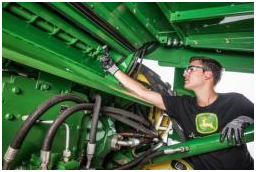 Quick-engage booster bar adjustment
Quick-engage booster bar adjustment
The quick-engage booster bar is adjustable from the outside via the stone trap with a 24-mm (0.95-in.) wrench. It has two positions. In the engaged position, the concave entrance features a profiled rasp bar. In the disengaged position, the concave entrance features a smooth transition plate. Adjustment can be completed easily within minutes.
Material flow coming from the feederhouse passing the booster bar is slowed down; this increases the threshing efficiency. The booster bar does not have a negative influence on the crop flow or the grain quality. The booster bar increases threshing efficiency in hard-to-thresh crops without closing the de-awning plates, allowing maximum separation at the concave area.
NOTE: The booster bar is standard on the T670.
8449 |
Quick-engage booster bar |
Extra-fast unloading system
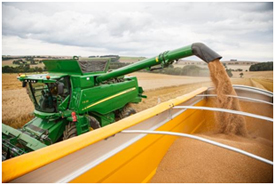

The fast unloading system of the T670 provides a rate of 125 L/sec (3.3 bu/sec). Compared to the previous unloading system, this ensures an unloading rate that is 50 percent faster and is reflected as a time saving when unloading on the headland.
The higher unload rate is achieved by grain tank cross augers, an increased discharge housing including vertical auger, and an overall higher speed of the unloading system.
Enhanced extra-fine-cut residue system
 Extra-fine-cut chopper rotor and housing
Extra-fine-cut chopper rotor and housing

The improved extra-fine-cut straw chopper delivers excellent chopping quality and best-in-class residue distribution of chopped material in the field with a cutting width up to 10.70 m (35 ft).
The extra-fine-cut chopper comes standard with serrated chopper knives, which ensure superior splicing of the straw and improved straw rotting process. The extra-fine-cut chopper is highly recommended for producers with no tillage or minimum tillage operations.
The optional dual-speed chopper drive provides flexibility to match all crops and conditions.
5771 |
Extra-fine-cut chopper with serrated knives, remote adjustable tailboard, and factory-installed wind paddles |
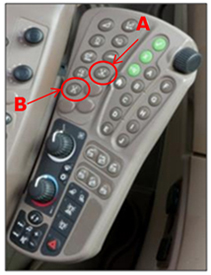 Armrest adjustment
Armrest adjustment

The extra-fine-cut chopper comes standard with a remote adjustable tailboard.
The remote adjustable tailboard can be adjusted from the cab conveniently via armrest control buttons (button A). The in-cab adjustment includes a unique tailboard position swap button (button B); by pressing the button on the armrest, the tailboard vanes automatically swap from left to right stored position and vice versa.
False floor geometry housing
The extra-fine-cut chopper housing follows the contour of the rotating knifes. This false floor geometry narrows the gap between the rotating knife and the chopper housing to a 4–5 mm (0.16-0.20-in.) closing at a wrapping angle of 83 degrees. It requires no adjustments and does not require any maintenance or replacements.
Wind paddle
The T670 with extra-fine-cut chopper comes standard equipped with wind paddles, which are factory installed on two knife rows. The wind paddles are mounted with bushings to withstand impacts from foreign objects. Equipped with wind paddles, the extra-fine-cut chopper is able to spread the chopped straw evenly up to 10.70 m (35 ft). Wind paddles are more effective than active radial spreaders, which are normally hydraulically driven.
Windrow sheet
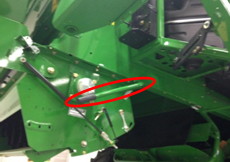 Windrow deflector plate
Windrow deflector plate
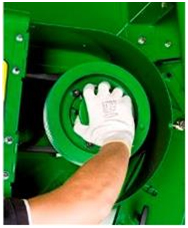 Straw chopper clutch
Straw chopper clutch
A single lever operates the windrow deflector plate. Operated on the right side, the straw is guided into the chopper or down on the ground for windrowing.
The straw chopper is directly driven from the main engine gearcase and automatically engages with the separator drive. A heavy-duty power belt reliably transmits drive power to the chopper. A reliable clutch is used for engaging and disengaging the chopper rotor.
Counter knives
 Counter knives adjustment
Counter knives adjustment

The extra-fine-cut chopper comes standard with a counter knife row, which is infinitely adjustable with two large leavers on each side. To secure the position, only one bolt needs to be tightened at each side.
Grouser bar
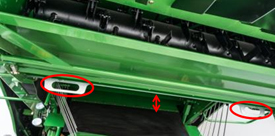 Grouser bar adjustment
Grouser bar adjustment

The extra-fine-cut chopper features a redesigned grouser bar, which is infinitely adjustable with a slide bar. To reduce the length of chopped material in green straw conditions, the grouser bar should be engaged. In dry straw conditions, it improves the splicing of the straw. To decrease fuel consumption, it is recommended to remove the grouser bar when chopping other crops such as corn, rape seed, beans, peas, and sunflower.
Tailboard angle adjustment
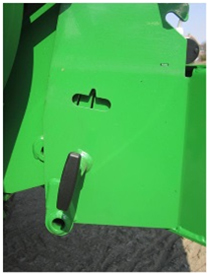 Tailboard angle adjustment
Tailboard angle adjustment
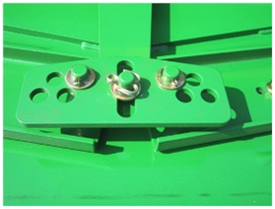 Tailboard vane adjustment
Tailboard vane adjustment
The tailboard angle can be adjusted without tools in three positions with a lever on each side.
In addition to the three-point tailboard adjustment, the vane angle can be set in four additional positions to ensure the spreading width of the residue matches all cutting platforms up to 10.70 m (35 ft).
The extra-fine-cut chopper comes standard with a 10-vane electrical tailboard design.
On-board air compressor
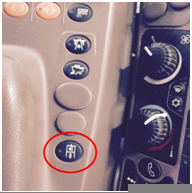 Air compressor engagement button
Air compressor engagement button
To improve serviceability and cleaning of the entire combine after a long and dusty working day, a factory-installed air compressor is available as an option.
The air compressor features three air take-off couplers: one on the left side near the toolbox compartment, one on the right side below the fuel tank, and one on the engine deck. With a 10-m (32.8-ft) hose, an additional air pistol, and a 125-cm (49.2-in.) lance, each point on the machine can be reached comfortably, easily, and quickly.
The air connection valve is activated with the air compressor engagement button on the armrest. Air can be used via the quick couplers. The air compressor engagement button can be activated when the machine is not moving, the separator is disengaged, and the park brake is activated.
Once the air compressor is engaged by a button on the armrest, the system starts to fill the 60-L (16-gal.) air reservoir tank until a shut- off pressure of 8 bars (116 psi) is reached. The system automatically stops to ensure power is only consumed if necessary.
NOTE: The air compressor option has not been optimized for operation of air tools and is not recommended to blow out engine air filter or debris management filter with the engine in operation.
NOTE: It is recommended to drain moisture from the air tank daily when the machine is in use to prevent degradation in the performance of the system. When servicing the air compressor, it is recommended to expel all stored air from the system.
8649 |
Air compressor
Factory installed |
Features
ActiveYield™ system: Automatic yield calibration for corn, soybeans, wheat, canola, and barley
ActiveYield delivers automatic yield calibrations to the operator without spending time manually performing yield calibrations.
Feature benefit:
- Simplified yield calibrations for improved uptime in the field
- Simplified data collection for use during and after harvest

Functionality:
ActiveYield eliminates time-consuming manual yield calibrations and replaces them with automated sensors that calibrate the machine by measuring the grain as the tank fills. This enables decisions to be made in real time without leaving the cab.
 ActiveYield sensors in grain tank
ActiveYield sensors in grain tank
When the ActiveYield option is enabled and the Terrain Compensation Module (TCM) in the StarFire™ 3000 or StarFire 6000 Receiver has been calibrated, ActiveYield is ready to go to work. As grain is harvested and enters the tank, the three sensors within the grain tank collectively measure the grain as it piles over the cross auger covers. If all conditions are acceptable (header and separator on, grain is flowing, and machine level is within 4 degrees) load collection occurs from 900 through 3000 kg (2000 through 6600 lb).
Any pitch and roll of more than 4 degrees from center during load collection will cause the system to reject that load due to the grain pile shifting in the tank. A new calibration load starts once grain is below the sensors on the cross auger covers.
Stored calibration loads are replaced by new ones as the system continues to collect data. The system may be disabled at any time by accessing the moisture setup page and unchecking the ActiveYield box if manual yield calibration is desired.
 ActiveYield calibration location
ActiveYield calibration location
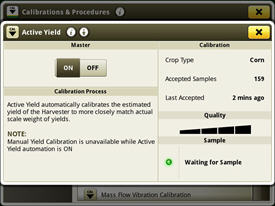 ActiveYield Information
ActiveYield Information
ActiveYield is available for model year 2016 through model year 2019 S760, S770, S780, and S790 Combines and requires the 4600 CommandCenter™ Display, GreenStar™ 3 2630 Display, or GreenStar 3 CommandCenter. Additionally, a StarFire 3000 or 6000 Receiver must be installed on the combine with the TCM calibrated for ActiveYield to detect machine pitch correctly. Manual yield calibration is not required as each crop has a built-in default value.
Harvest Doc™ system yield data collected by an ActiveYield system is only compatible with the John Deere Operations Center. John Deere does not guarantee compatibility of ActiveYield collected documentation with John Deere APEX™ software or third-party software systems.
Combine Advisor™
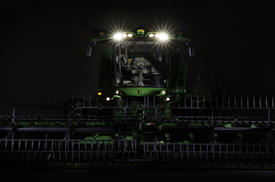
Combine Advisor is a suite of technologies designed to maximize harvesting profits. The features help the operator set and optimize the S700 Combine and then automates the combine to maintain performance target as conditions change. Purchasing Combine Advisor grants access to the Combine Advisor application, which houses three automation technologies: HarvestSmart™ system for automation of feed rate, Active Terrain Adjustment™ system for terrain change management, and Auto Maintain with ActiveVision™ cameras for crop condition change management.
Combine Advisor also provides easy navigation of the S700 set and optimize features: harvest settings application for initial set up and setting storage, VisionTrak system for monitoring losses, and Optimize Performance for step-by-step guidance of combine setting optimization. Once John Deere Combine Advisor is set into motion, the operator will experience ease-of-use benefits coupled with increased productivity.
Code |
Description |
1962
|
Combine Advisor Base features, plus Active Terrain Adjustment and Combine Advisor. Includes ActiveVision cameras.
Base features include Optimize Performance, TouchSet™ system, VisionTrak, HarvestSmart, and engine speed management. HarvestSmart and engine speed management only included with code 2020 (ProDrive™ transmission). Engine speed management only available with Final Tier 4 (FT4) engines. |
Combine Advisor hardware and software
Combine Advisor bundles are available for model year 2018 and future models. The bundles include ActiveVision cameras, harnesses, Auto Maintain, and software.
Dealer installation instructions are included, as weldments and drilling are required. The process will most likely take around 10 hours of labor.
| Bundle | Description |
BXE11034 |
Combine Advisor retrofit bundle for S760 and S770 Combines Also requires BXE10948 Active Terrain Adjustment bundle if the combine is not already equipped with code 1961 (base features + Active Terrain Adjustment) |
| BXE11035 | Combine Advisor retrofit bundle for S780 and S790 Combines Also requires BXE10948 Active Terrain Adjustment bundle if the combine is not already equipped with code 1961 (base features + Active Terrain Adjustment) |
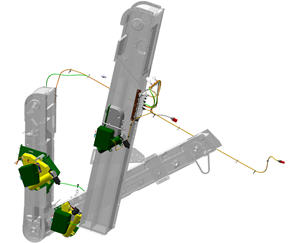 Combine Advisor retrofit bundle components
Combine Advisor retrofit bundle components
Combine Advisor video
- John Deere Combine Advisor Package (full video)
- The following videos are segments of the above full version:
Combine Advisor application
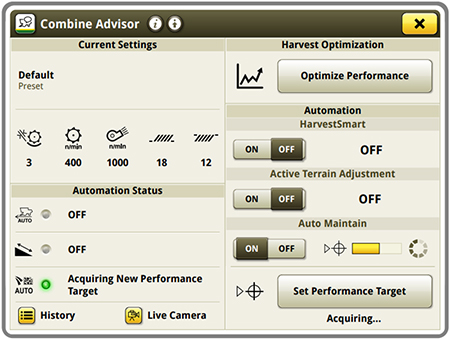 Combine Advisor run page
Combine Advisor run page
The Combine Advisor application provides the tools needed to set the combine to get the most out of it and automatically adjust settings to maintain optimum performance. Inside this application on the 4600 CommandCenter™ Display, the operator will find many tools including easy-to-adjust current machine settings, sensitivity settings for automation, application status indicators, automation activity history overviews, and live feeds of grain analysis cameras.
Additionally, the operator can access Optimize Performance, activate the three automation technologies, and set the performance targets the machine will automatically adjust to maintain.
Feature benefits:
- Efficient combine operation with a one-page application for animation technologies
- Improved combine settings management with settings, sensitivities, and status information all on one reference page
- Reduced operator training and efficient, easy control of harvest settings through an intuitive run page and user interface
Functionality:
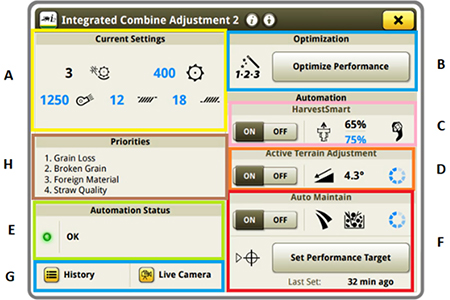 ICA2 run page, model years 2018 and 2019
ICA2 run page, model years 2018 and 2019
 Combine Advisor run page changes beginning with model year 2020
Combine Advisor run page changes beginning with model year 2020
| ICA2 run page, model year 2018 | Combine Advisor run page, model year 2020 |
| Section A (yellow highlight): takes the operator to the current settings for concave clearance, rotor speed, fan speed, chaffer clearance, and sieve clearance, giving quick access to critical combine adjustments. | Section A (yellow highlight): takes the operator to the current settings for concave clearance, rotor speed, fan speed, chaffer clearance, and sieve clearance, giving quick access to critical combine adjustments. It also shows the currently selected preset. |
| Section B (blue highlight): the Optimize Performance button helps the operator optimize combine performance. | Section B (blue highlight): the Optimize Performance button helps the operator optimize combine performance. |
| Section C (pink highlight): the HarvestSmart system automates ground speed control during harvest to maintain a constant crop load. | Section C (pink highlight): the HarvestSmart system automates ground speed control during harvest to maintain a constant engine load. The Manage Target with Grain Loss setting enables an automatic target adjustment based on loss levels. |
| Section D (orange highlight): the Active Terrain Adjustment system produces better grain quality and fewer losses while controlling tailings volume when harvesting up and down hills. | Section D (orange highlight): the Active Terrain Adjustment system produces better grain quality and fewer losses while controlling tailings volume when harvesting up and down hills. |
| Section E (green highlight): automation status | Section E (green highlight): Combine Advisor system – HarvestSmart, Active Terrain Adjustment, and Auto Maintain. |
| Section F (red highlight): Auto Maintain monitors the combine and makes adjustments to maintain the performance at the operator-set performance target. | Section F (red highlight): Auto Maintain monitors the combine and makes adjustments to maintain the performance at the operator-set performance target. |
| Section G (purple highlight): Auto Maintain also uses the buttons in section G to allow a glimpse into live views of the clean grain and tailings elevators and allows operators to use an analyzer function to see what Auto Maintain is seeing. It also shows a list of adjustments made by Auto Maintain and Active Terrain Adjustment. **In sections C, D and F select the screen area to see additional sensitivity settings for each system. |
Section G (purple highlight): Auto Maintain also uses the buttons in section G to allow a glimpse into live views of the clean grain and tailings elevators and allows operators to use an analyzer function to see what Auto Maintain is seeing. It also shows a list of adjustments made by Auto Maintain and Active Terrain Adjustment. **In sections C, D and E select the screen area to see additional sensitivity settings for each system. |
| Section H (brown highlight): indicates the operator’s priorities for automation | --- |
 |
|
Auto Maintain
Auto Maintain with ActiveVision cameras is technology that works to automatically adjust five primary S700 Combine settings to maintain the user set performance target. When harvesting corn, soybeans, wheat, canola, or barley, the combine will maintain the performance of everything from grain loss and grain quality, to foreign material in the grain tank. The ActiveVision cameras, along with grain loss monitors, are specifically designed to identify the impact of crop condition changes and adjust the combine to maintain the performance target, allowing the operator to focus on other challenges of harvest.
Feature benefits:
Simplify harvest by automating the critical workload of constantly managing combine settings when conditions change
Increase productivity by allowing ActiveVision cameras to identify and address tough-to-spot problems such as cracked grain
Provide flexibility in planning overall business and increase the efficiency of the combine independent of operator experience
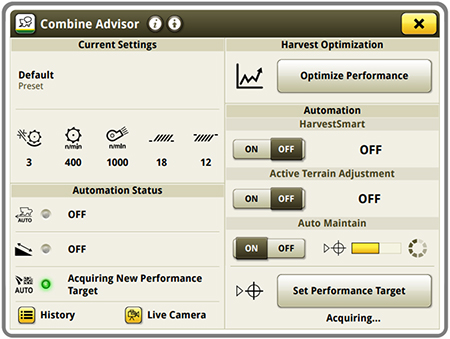 Combine Advisor run page
Combine Advisor run page
Functionality
Auto Maintain looks at the level at which the combine is performing, sets that as the goal, and automates combine settings to continually hit the target performance goal over time. Auto Maintain uses existing sensor inputs along with the ActiveVision cameras to make decisions for accurate combine adjustments. It does not use grain moisture as an input, however. Auto Maintain is able to hit the target goal by automatically making adjustments to the threshing speed, concave clearance, chaffer clearance, sieve clearance, and fan speed. The ActiveVision cameras have been trained to analyze the clean grain and tailings material and input that analysis into the Auto Maintain system. Auto Maintain will show the operator how it has been performing with a constantly updating historical graph of losses, grain quality, and foreign material in the clean grain. The green-shaded area below indicates the performance targets set. The colored lines show the ongoing levels of losses and quality. For example, the green, purple, and orange lines below show a period of time outside of the green-shaded acceptable area. Auto Maintain recognizes this and makes the appropriate adjustments to meet the set targets.
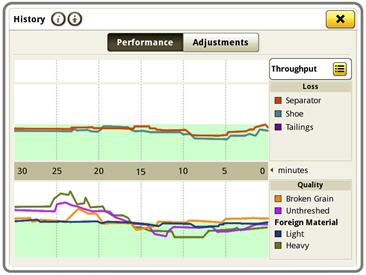 Historical Auto Maintain performance graph
Historical Auto Maintain performance graph
The ActiveVision cameras can detect broken and unthreshed grain. The cameras will also detect lightweight and heavy foreign material to make the appropriate combine settings changes. The system provides a live feed of both the grain and tailings cameras and will highlight the parameters outlined to make it easier to analyze. The live view and historical graphs update constantly, and the cameras will even tell the operator if there is debris on the lens.
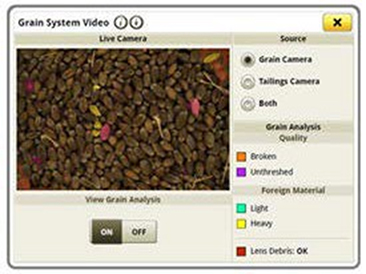 Grain analysis live view
Grain analysis live view
 |
Combine Advisor with Auto Maintain is available as a factory-installed option on combines since model year 2018. Auto Maintain is compatible in corn, soybeans, wheat, canola, and barley. Retrofit kits, BXE11034 and BXE11035 are available. Please refer to that section for more information. |
Additional Combine Advisor features
Take advantage of the Generation 4 CommandCenter™ display, designed for efficiency
The Generation 4 CommandCenter was designed to provide a consistent user experience by providing full-screen viewing of more run page modules, shortcut keys, and precision agriculture capabilities.
Expect easier set-up, along with increased operator confidence, thanks to a simple, customizable interface. The improved design of the Generation 4 CommandCenter also aids in an optimal operating experience and maximizes uptime.
In order to increase your efficiency, take advantage of the following features offered by the Generation 4 CommandCenter:
Layout manager
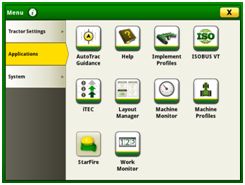 Layout manager selection page
Layout manager selection page
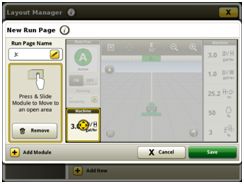 Layout manager module build
Layout manager module build
- Easily create page views that meet your needs and that are also equipped with default run pages.
- Users and access allow the owner or manager to lock out certain functions to prevent operators from accessing or changing settings with a defined four-digit code.
- Gather on-screen help by selecting the help icon on the shortcut bar on the bottom of every page.
Machine monitor
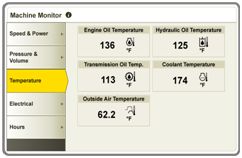 Machine monitor page
Machine monitor page
- The Machine Monitor application provides you instantaneous readings about the status or condition of your machine.
- This application shows parameters such as engine speed, coolant temperature, and ground speed.
Work monitor
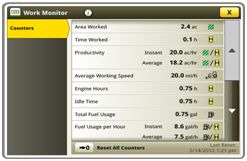 Work monitor page
Work monitor page
- The Work Monitor application displays performance information about the task being performed by the machine.
- You are shown averages, totals, and productivity of the machine, such as area worked, average working speed, and fuel usage.
- Work setup places the settings needed to properly setup features such as AutoTrac, Documentation, and Section Control in a single location. Settings include:
- Client, farm, and field
- Crop type
- Machine and implement dimensions
- Variety/hybrid and planting/seeding rates
- Variable rate prescriptions
- Product and application rates
- Application rates through the implement screens
Video capability
- Machines equipped with a 4200 CommandCenter are equipped with one video input, and the 4600 CommandCenter has four video inputs.
- You have the ability to set a variety of triggers. With each trigger, the image will then appear on the display.
Flags
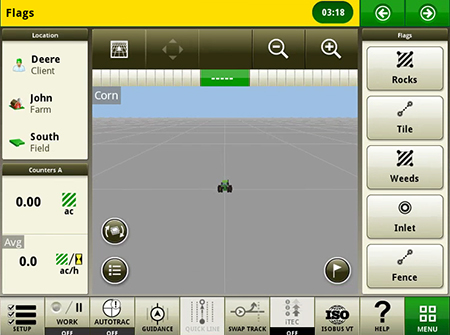 Create flags to mark items in the field
Create flags to mark items in the field
- Mark areas in the field that need special attention such as rocks, tile lines, or weed pressure.
- Flags previously recorded on the Gen 4 or GreenStar™ 3 2630 Display can be transferred between monitors.
- Flags previously recorded on the Gen 4 or GreenStar™ 3 2630 Display can be transferred between monitors.
Field boundaries
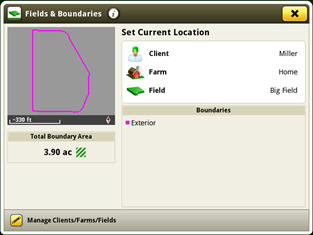 Boundary creation from coverage
Boundary creation from coverage
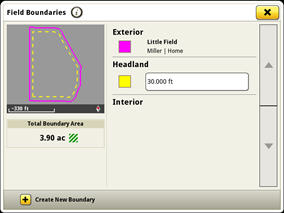 Headland creation
Headland creation
- Manually drive field boundaries with the Generation 4 CommandCenter or import existing boundary information from the GreenStar 3 2630 Display or John Deere Operations Center. Gen 4 documentation data can be used to create boundaries from coverage within the John Deere Operations Center.
Dual-display mode
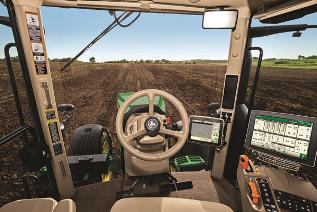 Dual display
Dual display
- Generation 4 CommandCenter may be configured to run with the following John Deere displays connected at the cornerpost of a John Deere tractor:
- GreenStar 2 1800 Display
- GreenStar 2 2600 Display
- GreenStar 3 2630 Display
- 4640 Universal Display
- 4240 Universal Display
NOTE: Vehicle applications will always be located on the Gen 4 CommandCenter.
Automatic base station switching
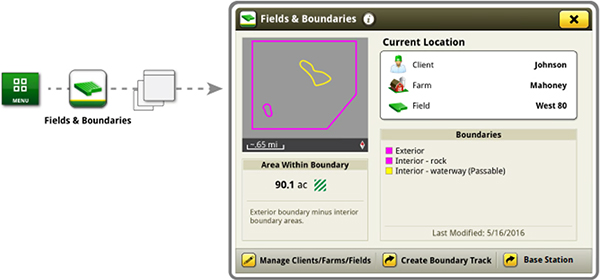 Setup base stations in Fields and Boundaries applications
Setup base stations in Fields and Boundaries applications
- Customers using John Deere RTK Radio 450 or 900 can link a base station to a desired client,/ farm,/ or field. This allows automatic switching to the associated base station when changing fields. The ability to import base station assignments into Operations Center and send back to machines will be available at a later date.
Video looping supported with Gen 4 4600 CommandCenter Display and 4640 Universal Display
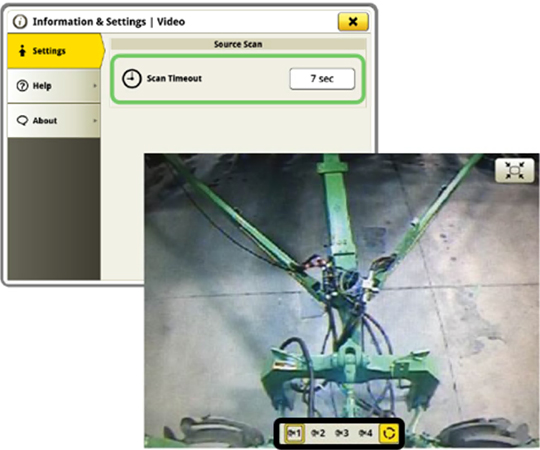 Scan through videos with video looping
Scan through videos with video looping
- This feature enables users to scan or loop through all of the available video feeds for a specified duration. The default scan time is set to 7 seconds per image. The scan time is customizable per image allowing for consistent visibility to all video feeds.
Automate grain cart control while unloading on-the-go with Gen 4 Machine Sync
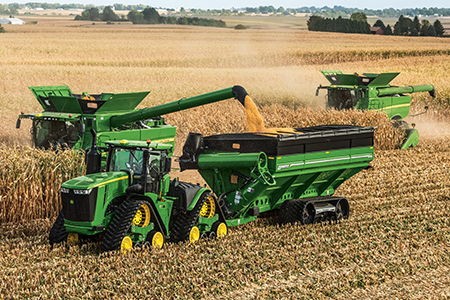
Harvest is hectic. Producers are focusing on getting all the crop from the field to the bin within a tight harvest window. Using Machine Sync, those producers can focus more on grain harvest and grain quality, and worry less about keeping the grain cart under the spout when unloading on the go. Gen 4 Machine Sync provides a solution to harvest stress by creating a wireless network between the tractor and combine to enable on-the-go unloading by synchronizing tractor speed and direction of travel with the combine.
Machine Sync works with In-Field Data Sharing to show the location of all combines and tractors within the fleet of Gen 4 machines harvesting in the field. Knowing the exact location of multiple combines as well as their grain tank fill level and unloading auger status allows the grain cart operators to be in the right place at the right time.
High-performance Dyna-Flo™ Plus cleaning system
The Dyna-Flo Plus cleaning shoe is the heart of the S700 Combine cleaning system. The system is made up of a unique design consisting of aluminum and high-strength steel that reduces overall weight while maintaining overall strength. The Dyna-Flo Plus cleaning shoe also features an enhanced drive system that requires only one flywheel for optimal shoe performance and maximizes uptime.
Feature benefit:
- Increased size of the sieve area by 12 percent for up to an additional 0.6 ha (1.5 acres) per hour of productivity.
- Tailings volume reduction of up to 28 percent in coarse grains and up to 14 percent in small grains.
- Weight reduction of 180 kg (396 lb) for smoother operation and reduced combine ground compaction.
 Dyna-Flo Plus cleaning shoe
Dyna-Flo Plus cleaning shoe
 Enhanced drive system
Enhanced drive system
Functionality:
The Dyna-Flo Plus cleaning system begins with conveyor augers located beneath the concave area, where the volume of threshed material is highest, to evenly move material onto the cleaning shoe (1). The deep auger troughs provide uniform distribution of material to the cleaning shoe with less bunching, even on sloping terrain and when harvesting up and down hills.
 Dyna-Flo Plus cleaning shoe
Dyna-Flo Plus cleaning shoe
Once grain is on the cleaning shoe, the raised-center front chaffer cleans up to 40 percent of free grain before it reaches the main chaffer (3). High-velocity air from the cleaning fan elevates any light material traveling over the end of the front chaffer, resulting in more aggressive separation of chaff and increased cleaning performance (2). The main chaffer provides grain separation from chaff as the grain passes through the main chaffer to the sieve (4).
The sieve provides proper sizing of grain from material other than grain (5). Any grain that passes through the sieve is elevated to the grain tank while some grain or material other than grain flows to the tailings return system for reprocessing. On S760, and S770 Combines, the tailings material is directed back into the threshing section of the separator for additional threshing. The tailings material on the S780 and S790 Combines are directed to the active tailings return system for additional threshing, and then directed back on the return pan and then onto the main chaffer for additional cleaning (6).
Automatic shifting with ProDrive™ transmission
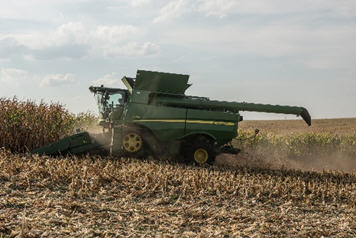 Harvesting in slopes
Harvesting in slopes
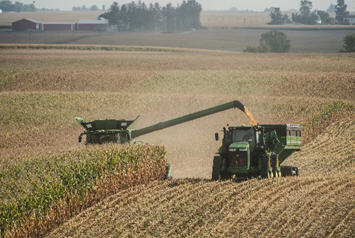 Harvesting in rolling ground
Harvesting in rolling ground
The industry-exclusive ProDrive system uses PowerShift™ transmission technology to automatically shift between two speed ranges as ground conditions and terrain change to keep the combine harvesting at the desired ground speed. Valuable harvest time will no longer be lost shifting on hills and when exiting fields to start transporting.
Feature benefit:
- Precise control of the combine speed (when going up or down hills) without the need to continuously monitor and adjust the multifunction control lever
- Retain high levels of productivity through the speed ranges with shift-on-the-go technology
- Maintain ground speed when engaging four-wheel drive (4WD) (if equipped)
- Operator-selected maximum speed within each range, allowing for more precise control of the combine in delicate operations (for example, when hooking up headers)
The ProDrive system on S700 Combines includes an integrated HarvestSmart™ feedrate control system to provide the maximum productivity and reduce operator stress and fatigue.
Functionality:
The ProDrive hydrostatic motor has a higher displacement than the previous hydrostatic systems. Both the pump and motor are variable-displacement components that allow ProDrive to maintain high levels of torque to the ground throughout each of the two operating-speed ranges.
Range one can be set for typical harvesting speeds. Range two can be used when higher speeds are needed during harvest or when transporting the combine.
The ground speed can be infinitely varied within both modes by the operator, using the multifunction control lever on the CommandARM™ armrest console. The multifunction lever regulates the high-capacity, variable hydrostatic pump and motor that drives the ground speed.
Using the navigation tools on the armrest, the operator can dial in the desired maximum-attainable speed within each of the two speed ranges. The maximum forward speed in either range can be set from 0 to 38.6 km/h (0 to 24 mph). The maximum speed in range one cannot be set higher than the maximum speed for range two. For example, if a maximum harvest speed of 13 km/h (8 mph) is desired and set, the full forward position of the hydrostatic control handle will deliver the speed of 13 km/h (8 mph).
The ProDrive transmission is equipped with an electrohydraulic differential lock with a four-pinion differential. Non-ProDrive combines have a two-pinion differential. When operating in muddy, hilly terrain or in sandy conditions that may cause one of the tires to lose traction, this differential lock enables the operator to maintain productivity. If traction is lost, the operator can quickly and easily engage the differential lock by pressing the differential lock button on the CommandARM armrest console. An indicator light within the button alerts the operator that the differential locking feature is engaged.
Platform tilt increases header productivity from the combine
Platform tilt allows operators to hydraulically adjust the fore-aft pitch of front-end equipment at the touch of a button from inside the cab to adapt to changing crop and field conditions.
Feature benefit:
- Maximizes performance of header in down crop or changing field conditions to extend the harvest day by up to one hour
- Achieves customized fore-aft angle of header with 17 degrees of tilt
- Adjusts from inside the cab, on the go
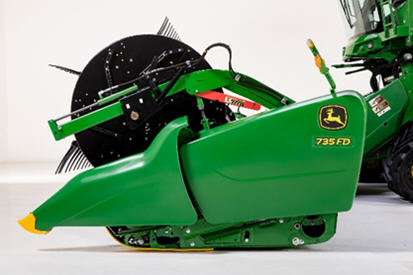 Hydraulic fore-aft feederhouse
Hydraulic fore-aft feederhouse
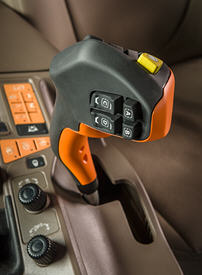 Hydraulic fore-aft multifunction control lever
Hydraulic fore-aft multifunction control lever
The platform tilt feature includes a different multifunction lever (hydro handle) to adjust the feederhouse tilt frame from the cab.
Functionality:
All S700 Combines provide an optional hydraulic header fore-aft tilt capability from the cab. However, all S700 Combines include a front-tilting faceplate as standard equipment. This tilting faceplate allows static fore-aft adjustment of up to 17 degrees of tilt on the feederhouse to accommodate different header and tire combinations to ensure a parallel cutterbar-to-ground relationship. This prevents the cutterbar knife guards from bulldozing or the platform healing on the rear of the skid shoes.
NOTE: Hydraulic fore-aft adjustment range is limited based upon the front-end equipment attached to prevent header frame damage. Check availability in local Price Pages.
TriStream™ rotor designed for coarse grains and easy-threshing small grains
The TriStream rotor is unique to John Deere because it features a slightly tapered design in the threshing area for best-in-class grain quality while dramatically reducing the growling that often comes with heavy rotor loads. The TriStream rotor is recommended for producers who harvest mainly coarse grains along with easy-threshing small grains.
The spiral vanes surrounding the rotor guide the crop material through the threshing and separating area in a pull-and-release action to improve performance. This John Deere S700 Combine feature will generate less power consumption.
Feature benefits:
- TriStream rotor technology reduces the force required to move material through the combine by as much as 20 percent, maximizing fuel efficiency.
- The rifling grooves on the threshing elements allow the bullet-shaped rotor to move material more efficiently, maximizing crop threshing performance and grain quality.
- Heavy-duty vanes on the top covers propel the crop smoothly rearward through the length of the rotor, ensuring all the threshed grain is separated.
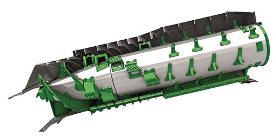 S700 TriStream rotor
S700 TriStream rotor
Functionality:
Fifteen cast-constructed threshing elements provide superior material handling with excellent grain quality. The elements spiral around the rotor to control material flow. In some harvesting environments, the dense-pack configuration (nine additional threshing elements) may be necessary.
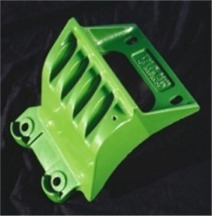 TriStream threshing elements
TriStream threshing elements
Conical top covers allow for smooth material movement within the threshing and separating area. The top covers have a radius larger than the rotor, allowing the material to expand as it travels along the top of the rotor. This design uses the pull-and-release action of crop material, aiding in the threshing and separating to reduce power consumption.
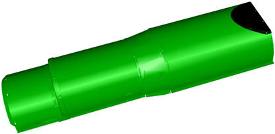 Conical top covers
Conical top covers
Variable-stream rotor designed for tough material handling
The industry-exclusive variable-stream rotor features a tapered design in the threshing section, which improves crop flow, enhances grain quality, and reduces power consumption. The variable-stream rotor with adjustable top cover transport vanes is recommended for producers of rice and in tough threshing conditions.
The variable-stream rotor smooths crop flow during tough handling conditions to maximize throughput. Along with the tough-material handling capabilities of the variable-stream rotor configuration, the straw quality and length can be improved due to the electrically adjustable top cover transport vanes.
Feature benefits:
- The longer rotor taper in the threshing area allows improved material handling by providing smoother crop flow through the combine, maximizing threshing performance and fuel efficiency.
- Electrically adjustable transport vanes allow operators to change the vane angle from the cab for improved straw quality.
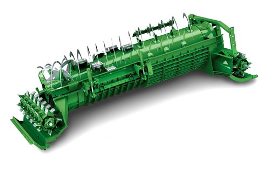 S700 variable-stream rotor
S700 variable-stream rotor
Functionality:
Fifteen cast-constructed threshing elements provide superior handling, improved durability and serviceability, and maintain excellent grain quality. The elements spiral around the rotor to move and control the material. In some harvesting conditions, 12 additional bolt-on threshing tines may be installed for increased material handling.
Rear discharge flights and a tapered rear cone improve material handoff to the rear discharge beater.
Electrically adjustable transport vanes allow operators to change the vane angle within the cab. Longer straw length can be accomplished when vanes are in the advanced position.
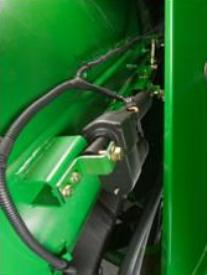 Electric actuator for adjustable vanes
Electric actuator for adjustable vanes
Features
ActiveYield™ system: Automatic yield calibration for corn, soybeans, wheat, canola, and barley
ActiveYield delivers automatic yield calibrations to the operator without spending time manually performing yield calibrations.
Feature benefit:
- Simplified yield calibrations for improved uptime in the field
- Simplified data collection for use during and after harvest

Functionality:
ActiveYield eliminates time-consuming manual yield calibrations and replaces them with automated sensors that calibrate the machine by measuring the grain as the tank fills. This enables decisions to be made in real time without leaving the cab.
 ActiveYield sensors in grain tank
ActiveYield sensors in grain tank
When the ActiveYield option is enabled and the Terrain Compensation Module (TCM) in the StarFire™ 3000 or StarFire 6000 Receiver has been calibrated, ActiveYield is ready to go to work. As grain is harvested and enters the tank, the three sensors within the grain tank collectively measure the grain as it piles over the cross auger covers. If all conditions are acceptable (header and separator on, grain is flowing, and machine level is within 4 degrees) load collection occurs from 900 through 3000 kg (2000 through 6600 lb).
Any pitch and roll of more than 4 degrees from center during load collection will cause the system to reject that load due to the grain pile shifting in the tank. A new calibration load starts once grain is below the sensors on the cross auger covers.
Stored calibration loads are replaced by new ones as the system continues to collect data. The system may be disabled at any time by accessing the moisture setup page and unchecking the ActiveYield box if manual yield calibration is desired.
 ActiveYield calibration location
ActiveYield calibration location
 ActiveYield Information
ActiveYield Information
ActiveYield is available for model year 2016 through model year 2019 S760, S770, S780, and S790 Combines and requires the 4600 CommandCenter™ Display, GreenStar™ 3 2630 Display, or GreenStar 3 CommandCenter. Additionally, a StarFire 3000 or 6000 Receiver must be installed on the combine with the TCM calibrated for ActiveYield to detect machine pitch correctly. Manual yield calibration is not required as each crop has a built-in default value.
Harvest Doc™ system yield data collected by an ActiveYield system is only compatible with the John Deere Operations Center. John Deere does not guarantee compatibility of ActiveYield collected documentation with John Deere APEX™ software or third-party software systems.
Combine Advisor™

Combine Advisor is a suite of technologies designed to maximize harvesting profits. The features help the operator set and optimize the S700 Combine and then automates the combine to maintain performance target as conditions change. Purchasing Combine Advisor grants access to the Combine Advisor application, which houses three automation technologies: HarvestSmart™ system for automation of feed rate, Active Terrain Adjustment™ system for terrain change management, and Auto Maintain with ActiveVision™ cameras for crop condition change management.
Combine Advisor also provides easy navigation of the S700 set and optimize features: harvest settings application for initial set up and setting storage, VisionTrak system for monitoring losses, and Optimize Performance for step-by-step guidance of combine setting optimization. Once John Deere Combine Advisor is set into motion, the operator will experience ease-of-use benefits coupled with increased productivity.
Code |
Description |
1962
|
Combine Advisor Base features, plus Active Terrain Adjustment and Combine Advisor. Includes ActiveVision cameras.
Base features include Optimize Performance, TouchSet™ system, VisionTrak, HarvestSmart, and engine speed management. HarvestSmart and engine speed management only included with code 2020 (ProDrive™ transmission). Engine speed management only available with Final Tier 4 (FT4) engines. |
Combine Advisor hardware and software
Combine Advisor bundles are available for model year 2018 and future models. The bundles include ActiveVision cameras, harnesses, Auto Maintain, and software.
Dealer installation instructions are included, as weldments and drilling are required. The process will most likely take around 10 hours of labor.
| Bundle | Description |
BXE11034 |
Combine Advisor retrofit bundle for S760 and S770 Combines Also requires BXE10948 Active Terrain Adjustment bundle if the combine is not already equipped with code 1961 (base features + Active Terrain Adjustment) |
| BXE11035 | Combine Advisor retrofit bundle for S780 and S790 Combines Also requires BXE10948 Active Terrain Adjustment bundle if the combine is not already equipped with code 1961 (base features + Active Terrain Adjustment) |
 Combine Advisor retrofit bundle components
Combine Advisor retrofit bundle components
Combine Advisor video
- John Deere Combine Advisor Package (full video)
- The following videos are segments of the above full version:
Combine Advisor application
 Combine Advisor run page
Combine Advisor run page
The Combine Advisor application provides the tools needed to set the combine to get the most out of it and automatically adjust settings to maintain optimum performance. Inside this application on the 4600 CommandCenter™ Display, the operator will find many tools including easy-to-adjust current machine settings, sensitivity settings for automation, application status indicators, automation activity history overviews, and live feeds of grain analysis cameras.
Additionally, the operator can access Optimize Performance, activate the three automation technologies, and set the performance targets the machine will automatically adjust to maintain.
Feature benefits:
- Efficient combine operation with a one-page application for animation technologies
- Improved combine settings management with settings, sensitivities, and status information all on one reference page
- Reduced operator training and efficient, easy control of harvest settings through an intuitive run page and user interface
Functionality:
 ICA2 run page, model years 2018 and 2019
ICA2 run page, model years 2018 and 2019
 Combine Advisor run page changes beginning with model year 2020
Combine Advisor run page changes beginning with model year 2020
| ICA2 run page, model year 2018 | Combine Advisor run page, model year 2020 |
| Section A (yellow highlight): takes the operator to the current settings for concave clearance, rotor speed, fan speed, chaffer clearance, and sieve clearance, giving quick access to critical combine adjustments. | Section A (yellow highlight): takes the operator to the current settings for concave clearance, rotor speed, fan speed, chaffer clearance, and sieve clearance, giving quick access to critical combine adjustments. It also shows the currently selected preset. |
| Section B (blue highlight): the Optimize Performance button helps the operator optimize combine performance. | Section B (blue highlight): the Optimize Performance button helps the operator optimize combine performance. |
| Section C (pink highlight): the HarvestSmart system automates ground speed control during harvest to maintain a constant crop load. | Section C (pink highlight): the HarvestSmart system automates ground speed control during harvest to maintain a constant engine load. The Manage Target with Grain Loss setting enables an automatic target adjustment based on loss levels. |
| Section D (orange highlight): the Active Terrain Adjustment system produces better grain quality and fewer losses while controlling tailings volume when harvesting up and down hills. | Section D (orange highlight): the Active Terrain Adjustment system produces better grain quality and fewer losses while controlling tailings volume when harvesting up and down hills. |
| Section E (green highlight): automation status | Section E (green highlight): Combine Advisor system – HarvestSmart, Active Terrain Adjustment, and Auto Maintain. |
| Section F (red highlight): Auto Maintain monitors the combine and makes adjustments to maintain the performance at the operator-set performance target. | Section F (red highlight): Auto Maintain monitors the combine and makes adjustments to maintain the performance at the operator-set performance target. |
| Section G (purple highlight): Auto Maintain also uses the buttons in section G to allow a glimpse into live views of the clean grain and tailings elevators and allows operators to use an analyzer function to see what Auto Maintain is seeing. It also shows a list of adjustments made by Auto Maintain and Active Terrain Adjustment. **In sections C, D and F select the screen area to see additional sensitivity settings for each system. |
Section G (purple highlight): Auto Maintain also uses the buttons in section G to allow a glimpse into live views of the clean grain and tailings elevators and allows operators to use an analyzer function to see what Auto Maintain is seeing. It also shows a list of adjustments made by Auto Maintain and Active Terrain Adjustment. **In sections C, D and E select the screen area to see additional sensitivity settings for each system. |
| Section H (brown highlight): indicates the operator’s priorities for automation | --- |
 |
|
Auto Maintain
Auto Maintain with ActiveVision cameras is technology that works to automatically adjust five primary S700 Combine settings to maintain the user set performance target. When harvesting corn, soybeans, wheat, canola, or barley, the combine will maintain the performance of everything from grain loss and grain quality, to foreign material in the grain tank. The ActiveVision cameras, along with grain loss monitors, are specifically designed to identify the impact of crop condition changes and adjust the combine to maintain the performance target, allowing the operator to focus on other challenges of harvest.
Feature benefits:
Simplify harvest by automating the critical workload of constantly managing combine settings when conditions change
Increase productivity by allowing ActiveVision cameras to identify and address tough-to-spot problems such as cracked grain
Provide flexibility in planning overall business and increase the efficiency of the combine independent of operator experience
 Combine Advisor run page
Combine Advisor run page
Functionality
Auto Maintain looks at the level at which the combine is performing, sets that as the goal, and automates combine settings to continually hit the target performance goal over time. Auto Maintain uses existing sensor inputs along with the ActiveVision cameras to make decisions for accurate combine adjustments. It does not use grain moisture as an input, however. Auto Maintain is able to hit the target goal by automatically making adjustments to the threshing speed, concave clearance, chaffer clearance, sieve clearance, and fan speed. The ActiveVision cameras have been trained to analyze the clean grain and tailings material and input that analysis into the Auto Maintain system. Auto Maintain will show the operator how it has been performing with a constantly updating historical graph of losses, grain quality, and foreign material in the clean grain. The green-shaded area below indicates the performance targets set. The colored lines show the ongoing levels of losses and quality. For example, the green, purple, and orange lines below show a period of time outside of the green-shaded acceptable area. Auto Maintain recognizes this and makes the appropriate adjustments to meet the set targets.
 Historical Auto Maintain performance graph
Historical Auto Maintain performance graph
The ActiveVision cameras can detect broken and unthreshed grain. The cameras will also detect lightweight and heavy foreign material to make the appropriate combine settings changes. The system provides a live feed of both the grain and tailings cameras and will highlight the parameters outlined to make it easier to analyze. The live view and historical graphs update constantly, and the cameras will even tell the operator if there is debris on the lens.
 Grain analysis live view
Grain analysis live view
 |
Combine Advisor with Auto Maintain is available as a factory-installed option on combines since model year 2018. Auto Maintain is compatible in corn, soybeans, wheat, canola, and barley. Retrofit kits, BXE11034 and BXE11035 are available. Please refer to that section for more information. |
Additional Combine Advisor features
Take advantage of the Generation 4 CommandCenter™ display, designed for efficiency
The Generation 4 CommandCenter was designed to provide a consistent user experience by providing full-screen viewing of more run page modules, shortcut keys, and precision agriculture capabilities.
Expect easier set-up, along with increased operator confidence, thanks to a simple, customizable interface. The improved design of the Generation 4 CommandCenter also aids in an optimal operating experience and maximizes uptime.
In order to increase your efficiency, take advantage of the following features offered by the Generation 4 CommandCenter:
Layout manager
 Layout manager selection page
Layout manager selection page
 Layout manager module build
Layout manager module build
- Easily create page views that meet your needs and that are also equipped with default run pages.
- Users and access allow the owner or manager to lock out certain functions to prevent operators from accessing or changing settings with a defined four-digit code.
- Gather on-screen help by selecting the help icon on the shortcut bar on the bottom of every page.
Machine monitor
 Machine monitor page
Machine monitor page
- The Machine Monitor application provides you instantaneous readings about the status or condition of your machine.
- This application shows parameters such as engine speed, coolant temperature, and ground speed.
Work monitor
 Work monitor page
Work monitor page
- The Work Monitor application displays performance information about the task being performed by the machine.
- You are shown averages, totals, and productivity of the machine, such as area worked, average working speed, and fuel usage.
- Work setup places the settings needed to properly setup features such as AutoTrac, Documentation, and Section Control in a single location. Settings include:
- Client, farm, and field
- Crop type
- Machine and implement dimensions
- Variety/hybrid and planting/seeding rates
- Variable rate prescriptions
- Product and application rates
- Application rates through the implement screens
Video capability
- Machines equipped with a 4200 CommandCenter are equipped with one video input, and the 4600 CommandCenter has four video inputs.
- You have the ability to set a variety of triggers. With each trigger, the image will then appear on the display.
Flags
 Create flags to mark items in the field
Create flags to mark items in the field
- Mark areas in the field that need special attention such as rocks, tile lines, or weed pressure.
- Flags previously recorded on the Gen 4 or GreenStar™ 3 2630 Display can be transferred between monitors.
- Flags previously recorded on the Gen 4 or GreenStar™ 3 2630 Display can be transferred between monitors.
Field boundaries
 Boundary creation from coverage
Boundary creation from coverage
 Headland creation
Headland creation
- Manually drive field boundaries with the Generation 4 CommandCenter or import existing boundary information from the GreenStar 3 2630 Display or John Deere Operations Center. Gen 4 documentation data can be used to create boundaries from coverage within the John Deere Operations Center.
Dual-display mode
 Dual display
Dual display
- Generation 4 CommandCenter may be configured to run with the following John Deere displays connected at the cornerpost of a John Deere tractor:
- GreenStar 2 1800 Display
- GreenStar 2 2600 Display
- GreenStar 3 2630 Display
- 4640 Universal Display
- 4240 Universal Display
NOTE: Vehicle applications will always be located on the Gen 4 CommandCenter.
Automatic base station switching
 Setup base stations in Fields and Boundaries applications
Setup base stations in Fields and Boundaries applications
- Customers using John Deere RTK Radio 450 or 900 can link a base station to a desired client,/ farm,/ or field. This allows automatic switching to the associated base station when changing fields. The ability to import base station assignments into Operations Center and send back to machines will be available at a later date.
Video looping supported with Gen 4 4600 CommandCenter Display and 4640 Universal Display
 Scan through videos with video looping
Scan through videos with video looping
- This feature enables users to scan or loop through all of the available video feeds for a specified duration. The default scan time is set to 7 seconds per image. The scan time is customizable per image allowing for consistent visibility to all video feeds.
Automate grain cart control while unloading on-the-go with Gen 4 Machine Sync

Harvest is hectic. Producers are focusing on getting all the crop from the field to the bin within a tight harvest window. Using Machine Sync, those producers can focus more on grain harvest and grain quality, and worry less about keeping the grain cart under the spout when unloading on the go. Gen 4 Machine Sync provides a solution to harvest stress by creating a wireless network between the tractor and combine to enable on-the-go unloading by synchronizing tractor speed and direction of travel with the combine.
Machine Sync works with In-Field Data Sharing to show the location of all combines and tractors within the fleet of Gen 4 machines harvesting in the field. Knowing the exact location of multiple combines as well as their grain tank fill level and unloading auger status allows the grain cart operators to be in the right place at the right time.
High-performance Dyna-Flo™ Plus cleaning system
The Dyna-Flo Plus cleaning shoe is the heart of the S700 Combine cleaning system. The system is made up of a unique design consisting of aluminum and high-strength steel that reduces overall weight while maintaining overall strength. The Dyna-Flo Plus cleaning shoe also features an enhanced drive system that requires only one flywheel for optimal shoe performance and maximizes uptime.
Feature benefit:
- Increased size of the sieve area by 12 percent for up to an additional 0.6 ha (1.5 acres) per hour of productivity.
- Tailings volume reduction of up to 28 percent in coarse grains and up to 14 percent in small grains.
- Weight reduction of 180 kg (396 lb) for smoother operation and reduced combine ground compaction.
 Dyna-Flo Plus cleaning shoe
Dyna-Flo Plus cleaning shoe
 Enhanced drive system
Enhanced drive system
Functionality:
The Dyna-Flo Plus cleaning system begins with conveyor augers located beneath the concave area, where the volume of threshed material is highest, to evenly move material onto the cleaning shoe (1). The deep auger troughs provide uniform distribution of material to the cleaning shoe with less bunching, even on sloping terrain and when harvesting up and down hills.
 Dyna-Flo Plus cleaning shoe
Dyna-Flo Plus cleaning shoe
Once grain is on the cleaning shoe, the raised-center front chaffer cleans up to 40 percent of free grain before it reaches the main chaffer (3). High-velocity air from the cleaning fan elevates any light material traveling over the end of the front chaffer, resulting in more aggressive separation of chaff and increased cleaning performance (2). The main chaffer provides grain separation from chaff as the grain passes through the main chaffer to the sieve (4).
The sieve provides proper sizing of grain from material other than grain (5). Any grain that passes through the sieve is elevated to the grain tank while some grain or material other than grain flows to the tailings return system for reprocessing. On S760, and S770 Combines, the tailings material is directed back into the threshing section of the separator for additional threshing. The tailings material on the S780 and S790 Combines are directed to the active tailings return system for additional threshing, and then directed back on the return pan and then onto the main chaffer for additional cleaning (6).
Automatic shifting with ProDrive™ transmission
 Harvesting in slopes
Harvesting in slopes
 Harvesting in rolling ground
Harvesting in rolling ground
The industry-exclusive ProDrive system uses PowerShift™ transmission technology to automatically shift between two speed ranges as ground conditions and terrain change to keep the combine harvesting at the desired ground speed. Valuable harvest time will no longer be lost shifting on hills and when exiting fields to start transporting.
Feature benefit:
- Precise control of the combine speed (when going up or down hills) without the need to continuously monitor and adjust the multifunction control lever
- Retain high levels of productivity through the speed ranges with shift-on-the-go technology
- Maintain ground speed when engaging four-wheel drive (4WD) (if equipped)
- Operator-selected maximum speed within each range, allowing for more precise control of the combine in delicate operations (for example, when hooking up headers)
The ProDrive system on S700 Combines includes an integrated HarvestSmart™ feedrate control system to provide the maximum productivity and reduce operator stress and fatigue.
Functionality:
The ProDrive hydrostatic motor has a higher displacement than the previous hydrostatic systems. Both the pump and motor are variable-displacement components that allow ProDrive to maintain high levels of torque to the ground throughout each of the two operating-speed ranges.
Range one can be set for typical harvesting speeds. Range two can be used when higher speeds are needed during harvest or when transporting the combine.
The ground speed can be infinitely varied within both modes by the operator, using the multifunction control lever on the CommandARM™ armrest console. The multifunction lever regulates the high-capacity, variable hydrostatic pump and motor that drives the ground speed.
Using the navigation tools on the armrest, the operator can dial in the desired maximum-attainable speed within each of the two speed ranges. The maximum forward speed in either range can be set from 0 to 38.6 km/h (0 to 24 mph). The maximum speed in range one cannot be set higher than the maximum speed for range two. For example, if a maximum harvest speed of 13 km/h (8 mph) is desired and set, the full forward position of the hydrostatic control handle will deliver the speed of 13 km/h (8 mph).
The ProDrive transmission is equipped with an electrohydraulic differential lock with a four-pinion differential. Non-ProDrive combines have a two-pinion differential. When operating in muddy, hilly terrain or in sandy conditions that may cause one of the tires to lose traction, this differential lock enables the operator to maintain productivity. If traction is lost, the operator can quickly and easily engage the differential lock by pressing the differential lock button on the CommandARM armrest console. An indicator light within the button alerts the operator that the differential locking feature is engaged.
Platform tilt increases header productivity from the combine
Platform tilt allows operators to hydraulically adjust the fore-aft pitch of front-end equipment at the touch of a button from inside the cab to adapt to changing crop and field conditions.
Feature benefit:
- Maximizes performance of header in down crop or changing field conditions to extend the harvest day by up to one hour
- Achieves customized fore-aft angle of header with 17 degrees of tilt
- Adjusts from inside the cab, on the go
 Hydraulic fore-aft feederhouse
Hydraulic fore-aft feederhouse
 Hydraulic fore-aft multifunction control lever
Hydraulic fore-aft multifunction control lever
The platform tilt feature includes a different multifunction lever (hydro handle) to adjust the feederhouse tilt frame from the cab.
Functionality:
All S700 Combines provide an optional hydraulic header fore-aft tilt capability from the cab. However, all S700 Combines include a front-tilting faceplate as standard equipment. This tilting faceplate allows static fore-aft adjustment of up to 17 degrees of tilt on the feederhouse to accommodate different header and tire combinations to ensure a parallel cutterbar-to-ground relationship. This prevents the cutterbar knife guards from bulldozing or the platform healing on the rear of the skid shoes.
NOTE: Hydraulic fore-aft adjustment range is limited based upon the front-end equipment attached to prevent header frame damage. Check availability in local Price Pages.
TriStream™ rotor designed for coarse grains and easy-threshing small grains
The TriStream rotor is unique to John Deere because it features a slightly tapered design in the threshing area for best-in-class grain quality while dramatically reducing the growling that often comes with heavy rotor loads. The TriStream rotor is recommended for producers who harvest mainly coarse grains along with easy-threshing small grains.
The spiral vanes surrounding the rotor guide the crop material through the threshing and separating area in a pull-and-release action to improve performance. This John Deere S700 Combine feature will generate less power consumption.
Feature benefits:
- TriStream rotor technology reduces the force required to move material through the combine by as much as 20 percent, maximizing fuel efficiency.
- The rifling grooves on the threshing elements allow the bullet-shaped rotor to move material more efficiently, maximizing crop threshing performance and grain quality.
- Heavy-duty vanes on the top covers propel the crop smoothly rearward through the length of the rotor, ensuring all the threshed grain is separated.
 S700 TriStream rotor
S700 TriStream rotor
Functionality:
Fifteen cast-constructed threshing elements provide superior material handling with excellent grain quality. The elements spiral around the rotor to control material flow. In some harvesting environments, the dense-pack configuration (nine additional threshing elements) may be necessary.
 TriStream threshing elements
TriStream threshing elements
Conical top covers allow for smooth material movement within the threshing and separating area. The top covers have a radius larger than the rotor, allowing the material to expand as it travels along the top of the rotor. This design uses the pull-and-release action of crop material, aiding in the threshing and separating to reduce power consumption.
 Conical top covers
Conical top covers
Variable-stream rotor designed for tough material handling
The industry-exclusive variable-stream rotor features a tapered design in the threshing section, which improves crop flow, enhances grain quality, and reduces power consumption. The variable-stream rotor with adjustable top cover transport vanes is recommended for producers of rice and in tough threshing conditions.
The variable-stream rotor smooths crop flow during tough handling conditions to maximize throughput. Along with the tough-material handling capabilities of the variable-stream rotor configuration, the straw quality and length can be improved due to the electrically adjustable top cover transport vanes.
Feature benefits:
- The longer rotor taper in the threshing area allows improved material handling by providing smoother crop flow through the combine, maximizing threshing performance and fuel efficiency.
- Electrically adjustable transport vanes allow operators to change the vane angle from the cab for improved straw quality.
 S700 variable-stream rotor
S700 variable-stream rotor
Functionality:
Fifteen cast-constructed threshing elements provide superior handling, improved durability and serviceability, and maintain excellent grain quality. The elements spiral around the rotor to move and control the material. In some harvesting conditions, 12 additional bolt-on threshing tines may be installed for increased material handling.
Rear discharge flights and a tapered rear cone improve material handoff to the rear discharge beater.
Electrically adjustable transport vanes allow operators to change the vane angle within the cab. Longer straw length can be accomplished when vanes are in the advanced position.
 Electric actuator for adjustable vanes
Electric actuator for adjustable vanes
Features
ActiveYield™ system: Automatic yield calibration for corn, soybeans, wheat, canola, and barley
ActiveYield delivers automatic yield calibrations to the operator without spending time manually performing yield calibrations.
Feature benefit:
- Simplified yield calibrations for improved uptime in the field
- Simplified data collection for use during and after harvest

Functionality:
ActiveYield eliminates time-consuming manual yield calibrations and replaces them with automated sensors that calibrate the machine by measuring the grain as the tank fills. This enables decisions to be made in real time without leaving the cab.
 ActiveYield sensors in grain tank
ActiveYield sensors in grain tank
When the ActiveYield option is enabled and the Terrain Compensation Module (TCM) in the StarFire™ 3000 or StarFire 6000 Receiver has been calibrated, ActiveYield is ready to go to work. As grain is harvested and enters the tank, the three sensors within the grain tank collectively measure the grain as it piles over the cross auger covers. If all conditions are acceptable (header and separator on, grain is flowing, and machine level is within 4 degrees) load collection occurs from 900 through 3000 kg (2000 through 6600 lb).
Any pitch and roll of more than 4 degrees from center during load collection will cause the system to reject that load due to the grain pile shifting in the tank. A new calibration load starts once grain is below the sensors on the cross auger covers.
Stored calibration loads are replaced by new ones as the system continues to collect data. The system may be disabled at any time by accessing the moisture setup page and unchecking the ActiveYield box if manual yield calibration is desired.
 ActiveYield calibration location
ActiveYield calibration location
 ActiveYield Information
ActiveYield Information
ActiveYield is available for model year 2016 through model year 2019 S760, S770, S780, and S790 Combines and requires the 4600 CommandCenter™ Display, GreenStar™ 3 2630 Display, or GreenStar 3 CommandCenter. Additionally, a StarFire 3000 or 6000 Receiver must be installed on the combine with the TCM calibrated for ActiveYield to detect machine pitch correctly. Manual yield calibration is not required as each crop has a built-in default value.
Harvest Doc™ system yield data collected by an ActiveYield system is only compatible with the John Deere Operations Center. John Deere does not guarantee compatibility of ActiveYield collected documentation with John Deere APEX™ software or third-party software systems.
Combine Advisor™

Combine Advisor is a suite of technologies designed to maximize harvesting profits. The features help the operator set and optimize the S700 Combine and then automates the combine to maintain performance target as conditions change. Purchasing Combine Advisor grants access to the Combine Advisor application, which houses three automation technologies: HarvestSmart™ system for automation of feed rate, Active Terrain Adjustment™ system for terrain change management, and Auto Maintain with ActiveVision™ cameras for crop condition change management.
Combine Advisor also provides easy navigation of the S700 set and optimize features: harvest settings application for initial set up and setting storage, VisionTrak system for monitoring losses, and Optimize Performance for step-by-step guidance of combine setting optimization. Once John Deere Combine Advisor is set into motion, the operator will experience ease-of-use benefits coupled with increased productivity.
Code |
Description |
1962
|
Combine Advisor Base features, plus Active Terrain Adjustment and Combine Advisor. Includes ActiveVision cameras.
Base features include Optimize Performance, TouchSet™ system, VisionTrak, HarvestSmart, and engine speed management. HarvestSmart and engine speed management only included with code 2020 (ProDrive™ transmission). Engine speed management only available with Final Tier 4 (FT4) engines. |
Combine Advisor hardware and software
Combine Advisor bundles are available for model year 2018 and future models. The bundles include ActiveVision cameras, harnesses, Auto Maintain, and software.
Dealer installation instructions are included, as weldments and drilling are required. The process will most likely take around 10 hours of labor.
| Bundle | Description |
BXE11034 |
Combine Advisor retrofit bundle for S760 and S770 Combines Also requires BXE10948 Active Terrain Adjustment bundle if the combine is not already equipped with code 1961 (base features + Active Terrain Adjustment) |
| BXE11035 | Combine Advisor retrofit bundle for S780 and S790 Combines Also requires BXE10948 Active Terrain Adjustment bundle if the combine is not already equipped with code 1961 (base features + Active Terrain Adjustment) |
 Combine Advisor retrofit bundle components
Combine Advisor retrofit bundle components
Combine Advisor video
- John Deere Combine Advisor Package (full video)
- The following videos are segments of the above full version:
Combine Advisor application
 Combine Advisor run page
Combine Advisor run page
The Combine Advisor application provides the tools needed to set the combine to get the most out of it and automatically adjust settings to maintain optimum performance. Inside this application on the 4600 CommandCenter™ Display, the operator will find many tools including easy-to-adjust current machine settings, sensitivity settings for automation, application status indicators, automation activity history overviews, and live feeds of grain analysis cameras.
Additionally, the operator can access Optimize Performance, activate the three automation technologies, and set the performance targets the machine will automatically adjust to maintain.
Feature benefits:
- Efficient combine operation with a one-page application for animation technologies
- Improved combine settings management with settings, sensitivities, and status information all on one reference page
- Reduced operator training and efficient, easy control of harvest settings through an intuitive run page and user interface
Functionality:
 ICA2 run page, model years 2018 and 2019
ICA2 run page, model years 2018 and 2019
 Combine Advisor run page changes beginning with model year 2020
Combine Advisor run page changes beginning with model year 2020
| ICA2 run page, model year 2018 | Combine Advisor run page, model year 2020 |
| Section A (yellow highlight): takes the operator to the current settings for concave clearance, rotor speed, fan speed, chaffer clearance, and sieve clearance, giving quick access to critical combine adjustments. | Section A (yellow highlight): takes the operator to the current settings for concave clearance, rotor speed, fan speed, chaffer clearance, and sieve clearance, giving quick access to critical combine adjustments. It also shows the currently selected preset. |
| Section B (blue highlight): the Optimize Performance button helps the operator optimize combine performance. | Section B (blue highlight): the Optimize Performance button helps the operator optimize combine performance. |
| Section C (pink highlight): the HarvestSmart system automates ground speed control during harvest to maintain a constant crop load. | Section C (pink highlight): the HarvestSmart system automates ground speed control during harvest to maintain a constant engine load. The Manage Target with Grain Loss setting enables an automatic target adjustment based on loss levels. |
| Section D (orange highlight): the Active Terrain Adjustment system produces better grain quality and fewer losses while controlling tailings volume when harvesting up and down hills. | Section D (orange highlight): the Active Terrain Adjustment system produces better grain quality and fewer losses while controlling tailings volume when harvesting up and down hills. |
| Section E (green highlight): automation status | Section E (green highlight): Combine Advisor system – HarvestSmart, Active Terrain Adjustment, and Auto Maintain. |
| Section F (red highlight): Auto Maintain monitors the combine and makes adjustments to maintain the performance at the operator-set performance target. | Section F (red highlight): Auto Maintain monitors the combine and makes adjustments to maintain the performance at the operator-set performance target. |
| Section G (purple highlight): Auto Maintain also uses the buttons in section G to allow a glimpse into live views of the clean grain and tailings elevators and allows operators to use an analyzer function to see what Auto Maintain is seeing. It also shows a list of adjustments made by Auto Maintain and Active Terrain Adjustment. **In sections C, D and F select the screen area to see additional sensitivity settings for each system. |
Section G (purple highlight): Auto Maintain also uses the buttons in section G to allow a glimpse into live views of the clean grain and tailings elevators and allows operators to use an analyzer function to see what Auto Maintain is seeing. It also shows a list of adjustments made by Auto Maintain and Active Terrain Adjustment. **In sections C, D and E select the screen area to see additional sensitivity settings for each system. |
| Section H (brown highlight): indicates the operator’s priorities for automation | --- |
 |
|
Auto Maintain
Auto Maintain with ActiveVision cameras is technology that works to automatically adjust five primary S700 Combine settings to maintain the user set performance target. When harvesting corn, soybeans, wheat, canola, or barley, the combine will maintain the performance of everything from grain loss and grain quality, to foreign material in the grain tank. The ActiveVision cameras, along with grain loss monitors, are specifically designed to identify the impact of crop condition changes and adjust the combine to maintain the performance target, allowing the operator to focus on other challenges of harvest.
Feature benefits:
Simplify harvest by automating the critical workload of constantly managing combine settings when conditions change
Increase productivity by allowing ActiveVision cameras to identify and address tough-to-spot problems such as cracked grain
Provide flexibility in planning overall business and increase the efficiency of the combine independent of operator experience
 Combine Advisor run page
Combine Advisor run page
Functionality
Auto Maintain looks at the level at which the combine is performing, sets that as the goal, and automates combine settings to continually hit the target performance goal over time. Auto Maintain uses existing sensor inputs along with the ActiveVision cameras to make decisions for accurate combine adjustments. It does not use grain moisture as an input, however. Auto Maintain is able to hit the target goal by automatically making adjustments to the threshing speed, concave clearance, chaffer clearance, sieve clearance, and fan speed. The ActiveVision cameras have been trained to analyze the clean grain and tailings material and input that analysis into the Auto Maintain system. Auto Maintain will show the operator how it has been performing with a constantly updating historical graph of losses, grain quality, and foreign material in the clean grain. The green-shaded area below indicates the performance targets set. The colored lines show the ongoing levels of losses and quality. For example, the green, purple, and orange lines below show a period of time outside of the green-shaded acceptable area. Auto Maintain recognizes this and makes the appropriate adjustments to meet the set targets.
 Historical Auto Maintain performance graph
Historical Auto Maintain performance graph
The ActiveVision cameras can detect broken and unthreshed grain. The cameras will also detect lightweight and heavy foreign material to make the appropriate combine settings changes. The system provides a live feed of both the grain and tailings cameras and will highlight the parameters outlined to make it easier to analyze. The live view and historical graphs update constantly, and the cameras will even tell the operator if there is debris on the lens.
 Grain analysis live view
Grain analysis live view
 |
Combine Advisor with Auto Maintain is available as a factory-installed option on combines since model year 2018. Auto Maintain is compatible in corn, soybeans, wheat, canola, and barley. Retrofit kits, BXE11034 and BXE11035 are available. Please refer to that section for more information. |
Additional Combine Advisor features
Take advantage of the Generation 4 CommandCenter™ display, designed for efficiency
The Generation 4 CommandCenter was designed to provide a consistent user experience by providing full-screen viewing of more run page modules, shortcut keys, and precision agriculture capabilities.
Expect easier set-up, along with increased operator confidence, thanks to a simple, customizable interface. The improved design of the Generation 4 CommandCenter also aids in an optimal operating experience and maximizes uptime.
In order to increase your efficiency, take advantage of the following features offered by the Generation 4 CommandCenter:
Layout manager
 Layout manager selection page
Layout manager selection page
 Layout manager module build
Layout manager module build
- Easily create page views that meet your needs and that are also equipped with default run pages.
- Users and access allow the owner or manager to lock out certain functions to prevent operators from accessing or changing settings with a defined four-digit code.
- Gather on-screen help by selecting the help icon on the shortcut bar on the bottom of every page.
Machine monitor
 Machine monitor page
Machine monitor page
- The Machine Monitor application provides you instantaneous readings about the status or condition of your machine.
- This application shows parameters such as engine speed, coolant temperature, and ground speed.
Work monitor
 Work monitor page
Work monitor page
- The Work Monitor application displays performance information about the task being performed by the machine.
- You are shown averages, totals, and productivity of the machine, such as area worked, average working speed, and fuel usage.
- Work setup places the settings needed to properly setup features such as AutoTrac, Documentation, and Section Control in a single location. Settings include:
- Client, farm, and field
- Crop type
- Machine and implement dimensions
- Variety/hybrid and planting/seeding rates
- Variable rate prescriptions
- Product and application rates
- Application rates through the implement screens
Video capability
- Machines equipped with a 4200 CommandCenter are equipped with one video input, and the 4600 CommandCenter has four video inputs.
- You have the ability to set a variety of triggers. With each trigger, the image will then appear on the display.
Flags
 Create flags to mark items in the field
Create flags to mark items in the field
- Mark areas in the field that need special attention such as rocks, tile lines, or weed pressure.
- Flags previously recorded on the Gen 4 or GreenStar™ 3 2630 Display can be transferred between monitors.
- Flags previously recorded on the Gen 4 or GreenStar™ 3 2630 Display can be transferred between monitors.
Field boundaries
 Boundary creation from coverage
Boundary creation from coverage
 Headland creation
Headland creation
- Manually drive field boundaries with the Generation 4 CommandCenter or import existing boundary information from the GreenStar 3 2630 Display or John Deere Operations Center. Gen 4 documentation data can be used to create boundaries from coverage within the John Deere Operations Center.
Dual-display mode
 Dual display
Dual display
- Generation 4 CommandCenter may be configured to run with the following John Deere displays connected at the cornerpost of a John Deere tractor:
- GreenStar 2 1800 Display
- GreenStar 2 2600 Display
- GreenStar 3 2630 Display
- 4640 Universal Display
- 4240 Universal Display
NOTE: Vehicle applications will always be located on the Gen 4 CommandCenter.
Automatic base station switching
 Setup base stations in Fields and Boundaries applications
Setup base stations in Fields and Boundaries applications
- Customers using John Deere RTK Radio 450 or 900 can link a base station to a desired client,/ farm,/ or field. This allows automatic switching to the associated base station when changing fields. The ability to import base station assignments into Operations Center and send back to machines will be available at a later date.
Video looping supported with Gen 4 4600 CommandCenter Display and 4640 Universal Display
 Scan through videos with video looping
Scan through videos with video looping
- This feature enables users to scan or loop through all of the available video feeds for a specified duration. The default scan time is set to 7 seconds per image. The scan time is customizable per image allowing for consistent visibility to all video feeds.
Automate grain cart control while unloading on-the-go with Gen 4 Machine Sync

Harvest is hectic. Producers are focusing on getting all the crop from the field to the bin within a tight harvest window. Using Machine Sync, those producers can focus more on grain harvest and grain quality, and worry less about keeping the grain cart under the spout when unloading on the go. Gen 4 Machine Sync provides a solution to harvest stress by creating a wireless network between the tractor and combine to enable on-the-go unloading by synchronizing tractor speed and direction of travel with the combine.
Machine Sync works with In-Field Data Sharing to show the location of all combines and tractors within the fleet of Gen 4 machines harvesting in the field. Knowing the exact location of multiple combines as well as their grain tank fill level and unloading auger status allows the grain cart operators to be in the right place at the right time.
Active Concave Isolation (ACI) increases threshing capacity
NOTE: Active Concave Isolation is only available on S780 and S790 Combines.
ACI increases throughput in tough threshing small grains and rice without sacrificing overall grain savings. This system allows producers to continue to harvest outside the optimal harvest window and conditions. The concaves are suspended by hydraulic cylinders that increase the amount of crop that is being threshed as well as reduces the amount of rotor noise that is heard by the operator.
Feature benefits:
- In tough threshing, small grains producers can see up to a 10 percent increase in machine capacity while maintaining their loss level when the combine is equipped with a tough crop packages
- In tough material handling conditions, the tough crop packages improve the throughput of the combine up to 20 percent to better utilize true machine performance outside the optimal harvest window and conditions, while accepting increased loss levels
- Improved drivability and ability to handle slugs
- Enhanced durability and uptime with the elimination of sheer bolts in the system
- Increased operator comfort with the reduction of concave banging noise
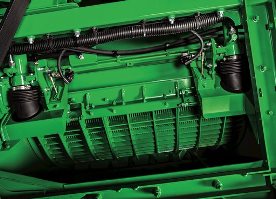 ACI
ACI
Functionality:
The ACI feature hydraulically suspends the concaves; the consistency of the concave gap is increased along with decreasing sensor drift for a more accurate concave distance. Material flow through the threshing section of the machine is smoother, giving more consistent threshing.
High-performance Dyna-Flo™ Plus cleaning system
The Dyna-Flo Plus cleaning shoe is the heart of the S700 Combine cleaning system. The system is made up of a unique design consisting of aluminum and high-strength steel that reduces overall weight while maintaining overall strength. The Dyna-Flo Plus cleaning shoe also features an enhanced drive system that requires only one flywheel for optimal shoe performance and maximizes uptime.
Feature benefit:
- Increased size of the sieve area by 12 percent for up to an additional 0.6 ha (1.5 acres) per hour of productivity.
- Tailings volume reduction of up to 28 percent in coarse grains and up to 14 percent in small grains.
- Weight reduction of 180 kg (396 lb) for smoother operation and reduced combine ground compaction.
 Dyna-Flo Plus cleaning shoe
Dyna-Flo Plus cleaning shoe
 Enhanced drive system
Enhanced drive system
Functionality:
The Dyna-Flo Plus cleaning system begins with conveyor augers located beneath the concave area, where the volume of threshed material is highest, to evenly move material onto the cleaning shoe (1). The deep auger troughs provide uniform distribution of material to the cleaning shoe with less bunching, even on sloping terrain and when harvesting up and down hills.
 Dyna-Flo Plus cleaning shoe
Dyna-Flo Plus cleaning shoe
Once grain is on the cleaning shoe, the raised-center front chaffer cleans up to 40 percent of free grain before it reaches the main chaffer (3). High-velocity air from the cleaning fan elevates any light material traveling over the end of the front chaffer, resulting in more aggressive separation of chaff and increased cleaning performance (2). The main chaffer provides grain separation from chaff as the grain passes through the main chaffer to the sieve (4).
The sieve provides proper sizing of grain from material other than grain (5). Any grain that passes through the sieve is elevated to the grain tank while some grain or material other than grain flows to the tailings return system for reprocessing. On S760, and S770 Combines, the tailings material is directed back into the threshing section of the separator for additional threshing. The tailings material on the S780 and S790 Combines are directed to the active tailings return system for additional threshing, and then directed back on the return pan and then onto the main chaffer for additional cleaning (6).
Automatic shifting with ProDrive™ transmission
 Harvesting in slopes
Harvesting in slopes
 Harvesting in rolling ground
Harvesting in rolling ground
The industry-exclusive ProDrive system uses PowerShift™ transmission technology to automatically shift between two speed ranges as ground conditions and terrain change to keep the combine harvesting at the desired ground speed. Valuable harvest time will no longer be lost shifting on hills and when exiting fields to start transporting.
Feature benefit:
- Precise control of the combine speed (when going up or down hills) without the need to continuously monitor and adjust the multifunction control lever
- Retain high levels of productivity through the speed ranges with shift-on-the-go technology
- Maintain ground speed when engaging four-wheel drive (4WD) (if equipped)
- Operator-selected maximum speed within each range, allowing for more precise control of the combine in delicate operations (for example, when hooking up headers)
The ProDrive system on S700 Combines includes an integrated HarvestSmart™ feedrate control system to provide the maximum productivity and reduce operator stress and fatigue.
Functionality:
The ProDrive hydrostatic motor has a higher displacement than the previous hydrostatic systems. Both the pump and motor are variable-displacement components that allow ProDrive to maintain high levels of torque to the ground throughout each of the two operating-speed ranges.
Range one can be set for typical harvesting speeds. Range two can be used when higher speeds are needed during harvest or when transporting the combine.
The ground speed can be infinitely varied within both modes by the operator, using the multifunction control lever on the CommandARM™ armrest console. The multifunction lever regulates the high-capacity, variable hydrostatic pump and motor that drives the ground speed.
Using the navigation tools on the armrest, the operator can dial in the desired maximum-attainable speed within each of the two speed ranges. The maximum forward speed in either range can be set from 0 to 38.6 km/h (0 to 24 mph). The maximum speed in range one cannot be set higher than the maximum speed for range two. For example, if a maximum harvest speed of 13 km/h (8 mph) is desired and set, the full forward position of the hydrostatic control handle will deliver the speed of 13 km/h (8 mph).
The ProDrive transmission is equipped with an electrohydraulic differential lock with a four-pinion differential. Non-ProDrive combines have a two-pinion differential. When operating in muddy, hilly terrain or in sandy conditions that may cause one of the tires to lose traction, this differential lock enables the operator to maintain productivity. If traction is lost, the operator can quickly and easily engage the differential lock by pressing the differential lock button on the CommandARM armrest console. An indicator light within the button alerts the operator that the differential locking feature is engaged.
Platform tilt increases header productivity from the combine
Platform tilt allows operators to hydraulically adjust the fore-aft pitch of front-end equipment at the touch of a button from inside the cab to adapt to changing crop and field conditions.
Feature benefit:
- Maximizes performance of header in down crop or changing field conditions to extend the harvest day by up to one hour
- Achieves customized fore-aft angle of header with 17 degrees of tilt
- Adjusts from inside the cab, on the go
 Hydraulic fore-aft feederhouse
Hydraulic fore-aft feederhouse
 Hydraulic fore-aft multifunction control lever
Hydraulic fore-aft multifunction control lever
The platform tilt feature includes a different multifunction lever (hydro handle) to adjust the feederhouse tilt frame from the cab.
Functionality:
All S700 Combines provide an optional hydraulic header fore-aft tilt capability from the cab. However, all S700 Combines include a front-tilting faceplate as standard equipment. This tilting faceplate allows static fore-aft adjustment of up to 17 degrees of tilt on the feederhouse to accommodate different header and tire combinations to ensure a parallel cutterbar-to-ground relationship. This prevents the cutterbar knife guards from bulldozing or the platform healing on the rear of the skid shoes.
NOTE: Hydraulic fore-aft adjustment range is limited based upon the front-end equipment attached to prevent header frame damage. Check availability in local Price Pages.
TriStream™ rotor designed for coarse grains and easy-threshing small grains
The TriStream rotor is unique to John Deere because it features a slightly tapered design in the threshing area for best-in-class grain quality while dramatically reducing the growling that often comes with heavy rotor loads. The TriStream rotor is recommended for producers who harvest mainly coarse grains along with easy-threshing small grains.
The spiral vanes surrounding the rotor guide the crop material through the threshing and separating area in a pull-and-release action to improve performance. This John Deere S700 Combine feature will generate less power consumption.
Feature benefits:
- TriStream rotor technology reduces the force required to move material through the combine by as much as 20 percent, maximizing fuel efficiency.
- The rifling grooves on the threshing elements allow the bullet-shaped rotor to move material more efficiently, maximizing crop threshing performance and grain quality.
- Heavy-duty vanes on the top covers propel the crop smoothly rearward through the length of the rotor, ensuring all the threshed grain is separated.
 S700 TriStream rotor
S700 TriStream rotor
Functionality:
Fifteen cast-constructed threshing elements provide superior material handling with excellent grain quality. The elements spiral around the rotor to control material flow. In some harvesting environments, the dense-pack configuration (nine additional threshing elements) may be necessary.
 TriStream threshing elements
TriStream threshing elements
Conical top covers allow for smooth material movement within the threshing and separating area. The top covers have a radius larger than the rotor, allowing the material to expand as it travels along the top of the rotor. This design uses the pull-and-release action of crop material, aiding in the threshing and separating to reduce power consumption.
 Conical top covers
Conical top covers
Variable-stream rotor designed for tough material handling
The industry-exclusive variable-stream rotor features a tapered design in the threshing section, which improves crop flow, enhances grain quality, and reduces power consumption. The variable-stream rotor with adjustable top cover transport vanes is recommended for producers of rice and in tough threshing conditions.
The variable-stream rotor smooths crop flow during tough handling conditions to maximize throughput. Along with the tough-material handling capabilities of the variable-stream rotor configuration, the straw quality and length can be improved due to the electrically adjustable top cover transport vanes.
Feature benefits:
- The longer rotor taper in the threshing area allows improved material handling by providing smoother crop flow through the combine, maximizing threshing performance and fuel efficiency.
- Electrically adjustable transport vanes allow operators to change the vane angle from the cab for improved straw quality.
 S700 variable-stream rotor
S700 variable-stream rotor
Functionality:
Fifteen cast-constructed threshing elements provide superior handling, improved durability and serviceability, and maintain excellent grain quality. The elements spiral around the rotor to move and control the material. In some harvesting conditions, 12 additional bolt-on threshing tines may be installed for increased material handling.
Rear discharge flights and a tapered rear cone improve material handoff to the rear discharge beater.
Electrically adjustable transport vanes allow operators to change the vane angle within the cab. Longer straw length can be accomplished when vanes are in the advanced position.
 Electric actuator for adjustable vanes
Electric actuator for adjustable vanes
Features
ActiveYield™ system: Automatic yield calibration for corn, soybeans, wheat, canola, and barley
ActiveYield delivers automatic yield calibrations to the operator without spending time manually performing yield calibrations.
Feature benefit:
- Simplified yield calibrations for improved uptime in the field
- Simplified data collection for use during and after harvest

Functionality:
ActiveYield eliminates time-consuming manual yield calibrations and replaces them with automated sensors that calibrate the machine by measuring the grain as the tank fills. This enables decisions to be made in real time without leaving the cab.
 ActiveYield sensors in grain tank
ActiveYield sensors in grain tank
When the ActiveYield option is enabled and the Terrain Compensation Module (TCM) in the StarFire™ 3000 or StarFire 6000 Receiver has been calibrated, ActiveYield is ready to go to work. As grain is harvested and enters the tank, the three sensors within the grain tank collectively measure the grain as it piles over the cross auger covers. If all conditions are acceptable (header and separator on, grain is flowing, and machine level is within 4 degrees) load collection occurs from 900 through 3000 kg (2000 through 6600 lb).
Any pitch and roll of more than 4 degrees from center during load collection will cause the system to reject that load due to the grain pile shifting in the tank. A new calibration load starts once grain is below the sensors on the cross auger covers.
Stored calibration loads are replaced by new ones as the system continues to collect data. The system may be disabled at any time by accessing the moisture setup page and unchecking the ActiveYield box if manual yield calibration is desired.
 ActiveYield calibration location
ActiveYield calibration location
 ActiveYield Information
ActiveYield Information
ActiveYield is available for model year 2016 through model year 2019 S760, S770, S780, and S790 Combines and requires the 4600 CommandCenter™ Display, GreenStar™ 3 2630 Display, or GreenStar 3 CommandCenter. Additionally, a StarFire 3000 or 6000 Receiver must be installed on the combine with the TCM calibrated for ActiveYield to detect machine pitch correctly. Manual yield calibration is not required as each crop has a built-in default value.
Harvest Doc™ system yield data collected by an ActiveYield system is only compatible with the John Deere Operations Center. John Deere does not guarantee compatibility of ActiveYield collected documentation with John Deere APEX™ software or third-party software systems.
Combine Advisor™

Combine Advisor is a suite of technologies designed to maximize harvesting profits. The features help the operator set and optimize the S700 Combine and then automates the combine to maintain performance target as conditions change. Purchasing Combine Advisor grants access to the Combine Advisor application, which houses three automation technologies: HarvestSmart™ system for automation of feed rate, Active Terrain Adjustment™ system for terrain change management, and Auto Maintain with ActiveVision™ cameras for crop condition change management.
Combine Advisor also provides easy navigation of the S700 set and optimize features: harvest settings application for initial set up and setting storage, VisionTrak system for monitoring losses, and Optimize Performance for step-by-step guidance of combine setting optimization. Once John Deere Combine Advisor is set into motion, the operator will experience ease-of-use benefits coupled with increased productivity.
Code |
Description |
1962
|
Combine Advisor Base features, plus Active Terrain Adjustment and Combine Advisor. Includes ActiveVision cameras.
Base features include Optimize Performance, TouchSet™ system, VisionTrak, HarvestSmart, and engine speed management. HarvestSmart and engine speed management only included with code 2020 (ProDrive™ transmission). Engine speed management only available with Final Tier 4 (FT4) engines. |
Combine Advisor hardware and software
Combine Advisor bundles are available for model year 2018 and future models. The bundles include ActiveVision cameras, harnesses, Auto Maintain, and software.
Dealer installation instructions are included, as weldments and drilling are required. The process will most likely take around 10 hours of labor.
| Bundle | Description |
BXE11034 |
Combine Advisor retrofit bundle for S760 and S770 Combines Also requires BXE10948 Active Terrain Adjustment bundle if the combine is not already equipped with code 1961 (base features + Active Terrain Adjustment) |
| BXE11035 | Combine Advisor retrofit bundle for S780 and S790 Combines Also requires BXE10948 Active Terrain Adjustment bundle if the combine is not already equipped with code 1961 (base features + Active Terrain Adjustment) |
 Combine Advisor retrofit bundle components
Combine Advisor retrofit bundle components
Combine Advisor video
- John Deere Combine Advisor Package (full video)
- The following videos are segments of the above full version:
Combine Advisor application
 Combine Advisor run page
Combine Advisor run page
The Combine Advisor application provides the tools needed to set the combine to get the most out of it and automatically adjust settings to maintain optimum performance. Inside this application on the 4600 CommandCenter™ Display, the operator will find many tools including easy-to-adjust current machine settings, sensitivity settings for automation, application status indicators, automation activity history overviews, and live feeds of grain analysis cameras.
Additionally, the operator can access Optimize Performance, activate the three automation technologies, and set the performance targets the machine will automatically adjust to maintain.
Feature benefits:
- Efficient combine operation with a one-page application for animation technologies
- Improved combine settings management with settings, sensitivities, and status information all on one reference page
- Reduced operator training and efficient, easy control of harvest settings through an intuitive run page and user interface
Functionality:
 ICA2 run page, model years 2018 and 2019
ICA2 run page, model years 2018 and 2019
 Combine Advisor run page changes beginning with model year 2020
Combine Advisor run page changes beginning with model year 2020
| ICA2 run page, model year 2018 | Combine Advisor run page, model year 2020 |
| Section A (yellow highlight): takes the operator to the current settings for concave clearance, rotor speed, fan speed, chaffer clearance, and sieve clearance, giving quick access to critical combine adjustments. | Section A (yellow highlight): takes the operator to the current settings for concave clearance, rotor speed, fan speed, chaffer clearance, and sieve clearance, giving quick access to critical combine adjustments. It also shows the currently selected preset. |
| Section B (blue highlight): the Optimize Performance button helps the operator optimize combine performance. | Section B (blue highlight): the Optimize Performance button helps the operator optimize combine performance. |
| Section C (pink highlight): the HarvestSmart system automates ground speed control during harvest to maintain a constant crop load. | Section C (pink highlight): the HarvestSmart system automates ground speed control during harvest to maintain a constant engine load. The Manage Target with Grain Loss setting enables an automatic target adjustment based on loss levels. |
| Section D (orange highlight): the Active Terrain Adjustment system produces better grain quality and fewer losses while controlling tailings volume when harvesting up and down hills. | Section D (orange highlight): the Active Terrain Adjustment system produces better grain quality and fewer losses while controlling tailings volume when harvesting up and down hills. |
| Section E (green highlight): automation status | Section E (green highlight): Combine Advisor system – HarvestSmart, Active Terrain Adjustment, and Auto Maintain. |
| Section F (red highlight): Auto Maintain monitors the combine and makes adjustments to maintain the performance at the operator-set performance target. | Section F (red highlight): Auto Maintain monitors the combine and makes adjustments to maintain the performance at the operator-set performance target. |
| Section G (purple highlight): Auto Maintain also uses the buttons in section G to allow a glimpse into live views of the clean grain and tailings elevators and allows operators to use an analyzer function to see what Auto Maintain is seeing. It also shows a list of adjustments made by Auto Maintain and Active Terrain Adjustment. **In sections C, D and F select the screen area to see additional sensitivity settings for each system. |
Section G (purple highlight): Auto Maintain also uses the buttons in section G to allow a glimpse into live views of the clean grain and tailings elevators and allows operators to use an analyzer function to see what Auto Maintain is seeing. It also shows a list of adjustments made by Auto Maintain and Active Terrain Adjustment. **In sections C, D and E select the screen area to see additional sensitivity settings for each system. |
| Section H (brown highlight): indicates the operator’s priorities for automation | --- |
 |
|
Auto Maintain
Auto Maintain with ActiveVision cameras is technology that works to automatically adjust five primary S700 Combine settings to maintain the user set performance target. When harvesting corn, soybeans, wheat, canola, or barley, the combine will maintain the performance of everything from grain loss and grain quality, to foreign material in the grain tank. The ActiveVision cameras, along with grain loss monitors, are specifically designed to identify the impact of crop condition changes and adjust the combine to maintain the performance target, allowing the operator to focus on other challenges of harvest.
Feature benefits:
Simplify harvest by automating the critical workload of constantly managing combine settings when conditions change
Increase productivity by allowing ActiveVision cameras to identify and address tough-to-spot problems such as cracked grain
Provide flexibility in planning overall business and increase the efficiency of the combine independent of operator experience
 Combine Advisor run page
Combine Advisor run page
Functionality
Auto Maintain looks at the level at which the combine is performing, sets that as the goal, and automates combine settings to continually hit the target performance goal over time. Auto Maintain uses existing sensor inputs along with the ActiveVision cameras to make decisions for accurate combine adjustments. It does not use grain moisture as an input, however. Auto Maintain is able to hit the target goal by automatically making adjustments to the threshing speed, concave clearance, chaffer clearance, sieve clearance, and fan speed. The ActiveVision cameras have been trained to analyze the clean grain and tailings material and input that analysis into the Auto Maintain system. Auto Maintain will show the operator how it has been performing with a constantly updating historical graph of losses, grain quality, and foreign material in the clean grain. The green-shaded area below indicates the performance targets set. The colored lines show the ongoing levels of losses and quality. For example, the green, purple, and orange lines below show a period of time outside of the green-shaded acceptable area. Auto Maintain recognizes this and makes the appropriate adjustments to meet the set targets.
 Historical Auto Maintain performance graph
Historical Auto Maintain performance graph
The ActiveVision cameras can detect broken and unthreshed grain. The cameras will also detect lightweight and heavy foreign material to make the appropriate combine settings changes. The system provides a live feed of both the grain and tailings cameras and will highlight the parameters outlined to make it easier to analyze. The live view and historical graphs update constantly, and the cameras will even tell the operator if there is debris on the lens.
 Grain analysis live view
Grain analysis live view
 |
Combine Advisor with Auto Maintain is available as a factory-installed option on combines since model year 2018. Auto Maintain is compatible in corn, soybeans, wheat, canola, and barley. Retrofit kits, BXE11034 and BXE11035 are available. Please refer to that section for more information. |
Additional Combine Advisor features
Take advantage of the Generation 4 CommandCenter™ display, designed for efficiency
The Generation 4 CommandCenter was designed to provide a consistent user experience by providing full-screen viewing of more run page modules, shortcut keys, and precision agriculture capabilities.
Expect easier set-up, along with increased operator confidence, thanks to a simple, customizable interface. The improved design of the Generation 4 CommandCenter also aids in an optimal operating experience and maximizes uptime.
In order to increase your efficiency, take advantage of the following features offered by the Generation 4 CommandCenter:
Layout manager
 Layout manager selection page
Layout manager selection page
 Layout manager module build
Layout manager module build
- Easily create page views that meet your needs and that are also equipped with default run pages.
- Users and access allow the owner or manager to lock out certain functions to prevent operators from accessing or changing settings with a defined four-digit code.
- Gather on-screen help by selecting the help icon on the shortcut bar on the bottom of every page.
Machine monitor
 Machine monitor page
Machine monitor page
- The Machine Monitor application provides you instantaneous readings about the status or condition of your machine.
- This application shows parameters such as engine speed, coolant temperature, and ground speed.
Work monitor
 Work monitor page
Work monitor page
- The Work Monitor application displays performance information about the task being performed by the machine.
- You are shown averages, totals, and productivity of the machine, such as area worked, average working speed, and fuel usage.
- Work setup places the settings needed to properly setup features such as AutoTrac, Documentation, and Section Control in a single location. Settings include:
- Client, farm, and field
- Crop type
- Machine and implement dimensions
- Variety/hybrid and planting/seeding rates
- Variable rate prescriptions
- Product and application rates
- Application rates through the implement screens
Video capability
- Machines equipped with a 4200 CommandCenter are equipped with one video input, and the 4600 CommandCenter has four video inputs.
- You have the ability to set a variety of triggers. With each trigger, the image will then appear on the display.
Flags
 Create flags to mark items in the field
Create flags to mark items in the field
- Mark areas in the field that need special attention such as rocks, tile lines, or weed pressure.
- Flags previously recorded on the Gen 4 or GreenStar™ 3 2630 Display can be transferred between monitors.
- Flags previously recorded on the Gen 4 or GreenStar™ 3 2630 Display can be transferred between monitors.
Field boundaries
 Boundary creation from coverage
Boundary creation from coverage
 Headland creation
Headland creation
- Manually drive field boundaries with the Generation 4 CommandCenter or import existing boundary information from the GreenStar 3 2630 Display or John Deere Operations Center. Gen 4 documentation data can be used to create boundaries from coverage within the John Deere Operations Center.
Dual-display mode
 Dual display
Dual display
- Generation 4 CommandCenter may be configured to run with the following John Deere displays connected at the cornerpost of a John Deere tractor:
- GreenStar 2 1800 Display
- GreenStar 2 2600 Display
- GreenStar 3 2630 Display
- 4640 Universal Display
- 4240 Universal Display
NOTE: Vehicle applications will always be located on the Gen 4 CommandCenter.
Automatic base station switching
 Setup base stations in Fields and Boundaries applications
Setup base stations in Fields and Boundaries applications
- Customers using John Deere RTK Radio 450 or 900 can link a base station to a desired client,/ farm,/ or field. This allows automatic switching to the associated base station when changing fields. The ability to import base station assignments into Operations Center and send back to machines will be available at a later date.
Video looping supported with Gen 4 4600 CommandCenter Display and 4640 Universal Display
 Scan through videos with video looping
Scan through videos with video looping
- This feature enables users to scan or loop through all of the available video feeds for a specified duration. The default scan time is set to 7 seconds per image. The scan time is customizable per image allowing for consistent visibility to all video feeds.
Automate grain cart control while unloading on-the-go with Gen 4 Machine Sync

Harvest is hectic. Producers are focusing on getting all the crop from the field to the bin within a tight harvest window. Using Machine Sync, those producers can focus more on grain harvest and grain quality, and worry less about keeping the grain cart under the spout when unloading on the go. Gen 4 Machine Sync provides a solution to harvest stress by creating a wireless network between the tractor and combine to enable on-the-go unloading by synchronizing tractor speed and direction of travel with the combine.
Machine Sync works with In-Field Data Sharing to show the location of all combines and tractors within the fleet of Gen 4 machines harvesting in the field. Knowing the exact location of multiple combines as well as their grain tank fill level and unloading auger status allows the grain cart operators to be in the right place at the right time.
Active Concave Isolation (ACI) increases threshing capacity
NOTE: Active Concave Isolation is only available on S780 and S790 Combines.
ACI increases throughput in tough threshing small grains and rice without sacrificing overall grain savings. This system allows producers to continue to harvest outside the optimal harvest window and conditions. The concaves are suspended by hydraulic cylinders that increase the amount of crop that is being threshed as well as reduces the amount of rotor noise that is heard by the operator.
Feature benefits:
- In tough threshing, small grains producers can see up to a 10 percent increase in machine capacity while maintaining their loss level when the combine is equipped with a tough crop packages
- In tough material handling conditions, the tough crop packages improve the throughput of the combine up to 20 percent to better utilize true machine performance outside the optimal harvest window and conditions, while accepting increased loss levels
- Improved drivability and ability to handle slugs
- Enhanced durability and uptime with the elimination of sheer bolts in the system
- Increased operator comfort with the reduction of concave banging noise
 ACI
ACI
Functionality:
The ACI feature hydraulically suspends the concaves; the consistency of the concave gap is increased along with decreasing sensor drift for a more accurate concave distance. Material flow through the threshing section of the machine is smoother, giving more consistent threshing.
High-performance Dyna-Flo™ Plus cleaning system
The Dyna-Flo Plus cleaning shoe is the heart of the S700 Combine cleaning system. The system is made up of a unique design consisting of aluminum and high-strength steel that reduces overall weight while maintaining overall strength. The Dyna-Flo Plus cleaning shoe also features an enhanced drive system that requires only one flywheel for optimal shoe performance and maximizes uptime.
Feature benefit:
- Increased size of the sieve area by 12 percent for up to an additional 0.6 ha (1.5 acres) per hour of productivity.
- Tailings volume reduction of up to 28 percent in coarse grains and up to 14 percent in small grains.
- Weight reduction of 180 kg (396 lb) for smoother operation and reduced combine ground compaction.
 Dyna-Flo Plus cleaning shoe
Dyna-Flo Plus cleaning shoe
 Enhanced drive system
Enhanced drive system
Functionality:
The Dyna-Flo Plus cleaning system begins with conveyor augers located beneath the concave area, where the volume of threshed material is highest, to evenly move material onto the cleaning shoe (1). The deep auger troughs provide uniform distribution of material to the cleaning shoe with less bunching, even on sloping terrain and when harvesting up and down hills.
 Dyna-Flo Plus cleaning shoe
Dyna-Flo Plus cleaning shoe
Once grain is on the cleaning shoe, the raised-center front chaffer cleans up to 40 percent of free grain before it reaches the main chaffer (3). High-velocity air from the cleaning fan elevates any light material traveling over the end of the front chaffer, resulting in more aggressive separation of chaff and increased cleaning performance (2). The main chaffer provides grain separation from chaff as the grain passes through the main chaffer to the sieve (4).
The sieve provides proper sizing of grain from material other than grain (5). Any grain that passes through the sieve is elevated to the grain tank while some grain or material other than grain flows to the tailings return system for reprocessing. On S760, and S770 Combines, the tailings material is directed back into the threshing section of the separator for additional threshing. The tailings material on the S780 and S790 Combines are directed to the active tailings return system for additional threshing, and then directed back on the return pan and then onto the main chaffer for additional cleaning (6).
Automatic shifting with ProDrive™ transmission
 Harvesting in slopes
Harvesting in slopes
 Harvesting in rolling ground
Harvesting in rolling ground
The industry-exclusive ProDrive system uses PowerShift™ transmission technology to automatically shift between two speed ranges as ground conditions and terrain change to keep the combine harvesting at the desired ground speed. Valuable harvest time will no longer be lost shifting on hills and when exiting fields to start transporting.
Feature benefit:
- Precise control of the combine speed (when going up or down hills) without the need to continuously monitor and adjust the multifunction control lever
- Retain high levels of productivity through the speed ranges with shift-on-the-go technology
- Maintain ground speed when engaging four-wheel drive (4WD) (if equipped)
- Operator-selected maximum speed within each range, allowing for more precise control of the combine in delicate operations (for example, when hooking up headers)
The ProDrive system on S700 Combines includes an integrated HarvestSmart™ feedrate control system to provide the maximum productivity and reduce operator stress and fatigue.
Functionality:
The ProDrive hydrostatic motor has a higher displacement than the previous hydrostatic systems. Both the pump and motor are variable-displacement components that allow ProDrive to maintain high levels of torque to the ground throughout each of the two operating-speed ranges.
Range one can be set for typical harvesting speeds. Range two can be used when higher speeds are needed during harvest or when transporting the combine.
The ground speed can be infinitely varied within both modes by the operator, using the multifunction control lever on the CommandARM™ armrest console. The multifunction lever regulates the high-capacity, variable hydrostatic pump and motor that drives the ground speed.
Using the navigation tools on the armrest, the operator can dial in the desired maximum-attainable speed within each of the two speed ranges. The maximum forward speed in either range can be set from 0 to 38.6 km/h (0 to 24 mph). The maximum speed in range one cannot be set higher than the maximum speed for range two. For example, if a maximum harvest speed of 13 km/h (8 mph) is desired and set, the full forward position of the hydrostatic control handle will deliver the speed of 13 km/h (8 mph).
The ProDrive transmission is equipped with an electrohydraulic differential lock with a four-pinion differential. Non-ProDrive combines have a two-pinion differential. When operating in muddy, hilly terrain or in sandy conditions that may cause one of the tires to lose traction, this differential lock enables the operator to maintain productivity. If traction is lost, the operator can quickly and easily engage the differential lock by pressing the differential lock button on the CommandARM armrest console. An indicator light within the button alerts the operator that the differential locking feature is engaged.
TriStream™ rotor designed for coarse grains and easy-threshing small grains
The TriStream rotor is unique to John Deere because it features a slightly tapered design in the threshing area for best-in-class grain quality while dramatically reducing the growling that often comes with heavy rotor loads. The TriStream rotor is recommended for producers who harvest mainly coarse grains along with easy-threshing small grains.
The spiral vanes surrounding the rotor guide the crop material through the threshing and separating area in a pull-and-release action to improve performance. This John Deere S700 Combine feature will generate less power consumption.
Feature benefits:
- TriStream rotor technology reduces the force required to move material through the combine by as much as 20 percent, maximizing fuel efficiency.
- The rifling grooves on the threshing elements allow the bullet-shaped rotor to move material more efficiently, maximizing crop threshing performance and grain quality.
- Heavy-duty vanes on the top covers propel the crop smoothly rearward through the length of the rotor, ensuring all the threshed grain is separated.
 S700 TriStream rotor
S700 TriStream rotor
Functionality:
Fifteen cast-constructed threshing elements provide superior material handling with excellent grain quality. The elements spiral around the rotor to control material flow. In some harvesting environments, the dense-pack configuration (nine additional threshing elements) may be necessary.
 TriStream threshing elements
TriStream threshing elements
Conical top covers allow for smooth material movement within the threshing and separating area. The top covers have a radius larger than the rotor, allowing the material to expand as it travels along the top of the rotor. This design uses the pull-and-release action of crop material, aiding in the threshing and separating to reduce power consumption.
 Conical top covers
Conical top covers
Variable-stream rotor designed for tough material handling
The industry-exclusive variable-stream rotor features a tapered design in the threshing section, which improves crop flow, enhances grain quality, and reduces power consumption. The variable-stream rotor with adjustable top cover transport vanes is recommended for producers of rice and in tough threshing conditions.
The variable-stream rotor smooths crop flow during tough handling conditions to maximize throughput. Along with the tough-material handling capabilities of the variable-stream rotor configuration, the straw quality and length can be improved due to the electrically adjustable top cover transport vanes.
Feature benefits:
- The longer rotor taper in the threshing area allows improved material handling by providing smoother crop flow through the combine, maximizing threshing performance and fuel efficiency.
- Electrically adjustable transport vanes allow operators to change the vane angle from the cab for improved straw quality.
 S700 variable-stream rotor
S700 variable-stream rotor
Functionality:
Fifteen cast-constructed threshing elements provide superior handling, improved durability and serviceability, and maintain excellent grain quality. The elements spiral around the rotor to move and control the material. In some harvesting conditions, 12 additional bolt-on threshing tines may be installed for increased material handling.
Rear discharge flights and a tapered rear cone improve material handoff to the rear discharge beater.
Electrically adjustable transport vanes allow operators to change the vane angle within the cab. Longer straw length can be accomplished when vanes are in the advanced position.
 Electric actuator for adjustable vanes
Electric actuator for adjustable vanes
Features
Powerful diesel engine delivers superb starting, idling, and throttle response
 XUV855 engine
XUV855 engine
 Remote intake and restriction indicator
Remote intake and restriction indicator
The machine is powered by an 854-cc (52.1-cu in.), 3-cylinder, liquid-cooled, four-cycle diesel engine. It produces 5.1 kgm (36.9 lb-ft) of torque at 2400 rpm.
The advanced engine delivers superb starting, idling, and throttle response during operation. With minimal noise vibration and harshness (NVH), the XUV855 is the smoothest and quietest running diesel in its class.
The engine offers the following performance and reliability features:
-
Indirect injection diesel with glow plugs ensures fast starts in cold temperatures
-
30.6 kW (22.8 hp*) at 2400 rpm
-
Overhead valve design for greater efficiency and fuel economy
-
Spin-on oil filter for easy servicing
-
Quiet operation through the entire rpm range
-
Molybdenum-coated pistons
-
High-stiffness cylinder block and gearcase
-
-
High-flow water pump and optimized water jackets maintain a steady operating temperature and eliminate hot spots
-
Full-pressure lubrication system
-
In-line mechanical fuel pump
-
Five-point, rubber isolated for quiet operation and minimal vibration
-
Dry replaceable dual-element air cleaner with remote intake and a restriction indicator
-
See-through coolant recovery tank permits the operator to check the coolant level without removing the radiator cap
-
Sealed radiator compartment keeps trash and debris on the outside of the grille
-
* The engine horsepower information is provided by the engine manufacturer to be used for comparison purposes only. The actual operating horsepower will be less.
Dual A-arm front and rear suspension provides a smooth ride over challenging terrain and excellent hauling characteristics
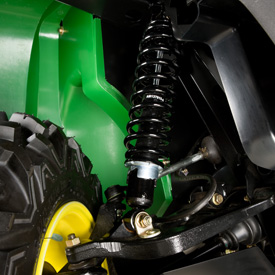 XUV front suspension detail
XUV front suspension detail

To complement the most capable frame available in a high-performance utility vehicle, the XUV is equipped with four-wheel independent suspension.
A dual A-arm front and rear suspension provides a smooth ride over challenging terrain and excellent hauling characteristics.
The entire suspension system has been optimized to handle no cargo to maximum cargo without compromising ride quality or vehicle stability.
Dual A-arm front suspension features include:
-
203.2 mm (8 in.) of travel provides ample compression and wheel extension, which keep all four wheels on the ground for superior traction and vehicle control
-
17.5-mm (0.6875-in.) solid anti-roll bar with fully rubber isolated connecting links and pivots for minimal vehicle body roll and quiet operation
-
Heavy-duty, nodular cast-iron knuckles to support the strut, constant-velocity (CV) shaft, and wheel
-
Maintenance-free rubber torsional A-arm pivots for long life and quiet operation
-
CV shaft protection from sticks that may puncture the rubber boot
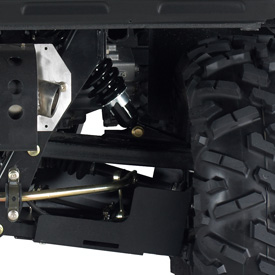 XUV rear suspension detail
XUV rear suspension detail

Dual A-arm independent rear suspension features include:
-
Unequal length, dual A-arm construction for superior wheel control and travel
-
228.6 mm (9 in.) of total travel provides ample compression and wheel extension, which keep all four wheels on the ground for superior traction, excellent ride quality, and vehicle control
-
Coil-over shocks absorb the most demanding terrain
-
A-arms made from square/rectangular tubing reduce weight while remaining rigid
-
Heavy-duty, nodular cast-iron uprights support wheel loads with a double row of ball bearings
-
CV driveshaft protection from sticks that may puncture the rubber boot
-
Rear sway bar for lateral stability
Superior terrain capability
The Gator™ XUV Crossover Series Utility Vehicle has a precision-engineered drivetrain system that fully utilizes engine power, optimizing acceleration, hauling, towing, and hill-climbing capabilities. Power is transmitted from the engine through a continuously-variable clutch system to the transaxle.
Key elements of the drive system include:
Variable-speed drive
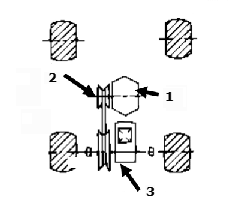 Variable-speed drive
Variable-speed drive
The variable-speed drive consists of two clutches and a drive belt:
- Drive clutch is attached to the engine.
- Driven clutch is attached to the transaxle.
Features include:
- The engine braking system utilizes a tight belt for operation, requiring an idler sleeve on the primary clutch for neutral. The secondary clutch is a new build-on-shaft design that utilizes a cam to tune the acceleration and deceleration of the vehicle. The clutch will stay engaged, providing deceleration until approximately 5 km/h (3 mph).
- The continuously variable transmission (CVT) air intake draws in 50 percent more air versus previous designs to reduce heat and the amount of water ingestion into the CVT system. The system will reduce belt slippage and improve durability.
- A low- and high-speed forward gear offering:
- Low range is 0 km/h to 43 km/h (0 mph to 27 mph), XUV825E and XUV825M S4
- Low range is 0 km/h to 24 km/h (0 mph to 15 mph), XUV855E and XUV855M S4
- High range is 0 km/h to 71 km/h (0 mph to 44 mph), XUV825E and XUV825M S4
- High range is 0 km/h to 51 km/h (0 mph to 32 mph), XUV855E and XUV855M S4
- Ability to creep along slowly to maneuver in tight spaces
- Standard full-clutch enclosure with high speed fan provides longer belt and clutch life
- High-ratio clutches with three cam weights for maximum belt clamp load in high-torque conditions
- Powertrain reduction ratios:
- The complete reduction ratios range for high gear is 8.6:1 at top speed and 42:1 at initial clutch engagement. This varies between the vehicles listed above.
- The complete reduction ratios range for low gear is 17.9:1 at top speed and 86.8:1 at initial clutch engagement. This varies between the vehicles listed above.
NOTE: Delivery and torque to the ground depends on tire size, which is a function of nominal size and pressure.
How the variable-speed drive works:
- As engine speed increases, the spring-loaded drive clutch is closed by weights being forced out by centrifugal force.
- As the drive clutch closes, the belt rides up to the largest diameter of the drive clutch and forces open the driven clutch.
- With the belt running in the smallest diameter of the driven clutch, the speed being transferred to the transaxle is increased.
- The driven clutch is designed to sense varying loads (inclines, mud, etc.) and constantly adjusts drive speed upward or downward so that engine rpm remains optimal.
Transaxle, mechanical front-wheel drive (MFWD), and constant-velocity (CV) shafts
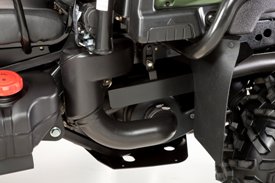 Side view of CVT intake and clutch on closure (XUV855 shown)
Side view of CVT intake and clutch on closure (XUV855 shown)
 Front differential rocker switch
Front differential rocker switch
 Rear end shot of transaxle/CV shafts
Rear end shot of transaxle/CV shafts
Operator interface
-
On-demand true four-wheel drive (4WD) system with an auto-locking front differential and dash-mounted electronic rocker switch is best in class; when the rocker switch is in the on 4WD position, the front differential will automatically lock for extra traction when needed, but when the rocker switch is in the off two-wheel drive (2WD) position, the vehicle will remain in 2WD
-
Provides exceptional traction in challenging conditions
-
Maintains turf-friendly operation in 2WD mode
-
Illuminated for visibility in low-light conditions
-
Transaxle
-
Two-speed, fully-enclosed, oil bath transaxle allows for superior pulling ability
-
Cast-aluminum design is the most robust in the industry
-
Helical forward and reverse gears are used for quiet operation
-
Rear traction assist (differential lock) is built in and can be engaged on demand
-
Allows locking the rear drive wheels together
-
Provides increased traction in tough spots
-
NOTE: Differential design reduces scuffing of the turf during turns because it allows the inside wheels to turn slower than the outside wheels
-
-
Neutral start safety interlock for engine ignition system
-
Large, sealed bearings are located inside the housing for better protection and durability
-
Contains gear case for transferring power to the MFWD
-
Splined shaft interfaces for maximum torque transfer and durability
-
All drive gears machined from highest grade gear steel
-
Protected by a skid plate
-
-
MFWD
-
Electronic design is auto-locking for ease of use
-
Performs like a locking differential when engaged, but like an open differential when cornering
-
Offers positive engagement of both front wheels in forward and reverse as a differential package
-
Automatic engagement on the fly—no shift linkages required
-
-
Protected by a skid plate and frame
-
-
Drive shafts
-
Rear CV shaft diameter measures 27 mm (1.1 in.) and is designed for peak engine and braking torque
-
Front CV shaft diameter measures 23.9 mm (0.94 in.) and is designed for peak engine torque
-
Propshaft (transaxle to MFWD shaft) diameter measures 23 mm (0.91 in.) and is designed for peak engine torque
-
All CV shaft and propshaft joints are maintenance free and protected by exclusive Neoprene boots for durability
-
Extra-durable deluxe cargo box ensures hard-working performance and longevity
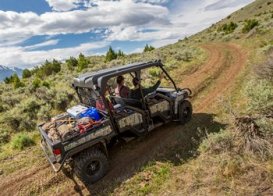 Deluxe cargo box
Deluxe cargo box

The deluxe cargo box consists of a 15 percent glass-filled polypropylene composite material that eliminates rust, dents, and reduces noise.
Deluxe cargo box tailgate
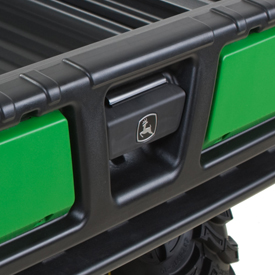 Tailgate handle
Tailgate handle
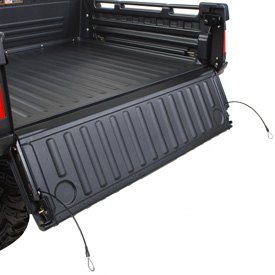 Tailgate lowered to 150 degrees
Tailgate lowered to 150 degrees
The tailgate can be opened or removed for easier cleanout and to carry longer items. The tailgate has been improved, features truck-like performance, and can be operated with one hand.
The standard installed lanyards can also be removed to lower the tailgate to 150 degrees for convenient loading and unloading tasks.
Deluxe cargo box tilt
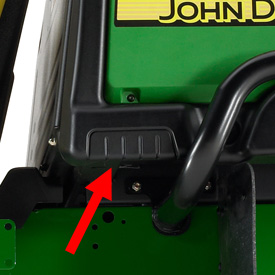 Integrated handle for manual cargo-box tilt
Integrated handle for manual cargo-box tilt

The deluxe cargo box is easier to latch, unlatch, raise, and lower with the integrated handle design and gas assist.
A prop rod is provided to hold the box in the upright position for operator convenience, as well as limit box pivot travel.
Integrated tie-down points
 Integrated tie-down point in cargo box bed
Integrated tie-down point in cargo box bed
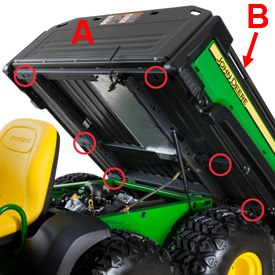 Additional tie-down points (TH 6X4 shown)
Additional tie-down points (TH 6X4 shown)
The deluxe cargo box offers integrated tie-down points for increased versatility. Tie down points are located in the following areas:
- Four corners inside the cargo-box bed
- Four points on the load guard directly behind the operator station (A)
- Tie-down bars on either side of the cargo box (B)
- Six points on the underside of the cargo-box frame (circled)
Converting deluxe cargo box to a flat bed
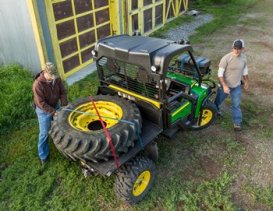 Deluxe cargo box converted to flat bed (XUV825 shown)
Deluxe cargo box converted to flat bed (XUV825 shown)
The deluxe cargo box easily converts to a flat bed. The flatbed configuration allows loading larger cargo.
Optional accessories
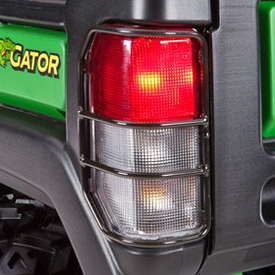 Brake and taillight with optional protector
Brake and taillight with optional protector
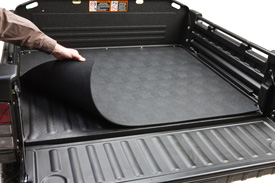 Bedmat—protects the steel floor from dents
Bedmat—protects the steel floor from dents
 Cargo box power lift
Cargo box power lift

Optional accessories for the deluxe cargo box include:
- Factory-installed brake and taillight
- Factory-installed spray-in liner (not shown)
- Improves skid resistance and surface abrasion protection
- Cargo box bed mat
- Cargo box power lift
Specifications
| Length | 1143 mm (45 in.) |
| Width | 1320 mm (52 in.) |
| Depth | 304 mm (11 in.) |
| Volume | 0.46 m3 (16.4 ft3) |
| Weight capacity | 454 kg (1000 lb) |
| Dump angle | 47 degrees |
CAUTION: Carrying extra-long cargo that extends beyond the box can adversely affect stability.
Equipped with power steering
This Gator™ XUV Crossover Utility Vehicle is equipped with power steering and a dual A-arm front suspension. These automotive-type systems exhibit excellent handling characteristics, as well as responsive steering and low steering effort:
-
Steel ball bearings secure the steering shaft and deliver smooth, responsive operation
-
Completely-sealed rack-and-pinion for long life
- Low steering ratio (lock-to-lock) provides more responsive steering and less operator input
-
Shaft U-joints are phased for a smooth, uninterrupted motion of the steering wheel
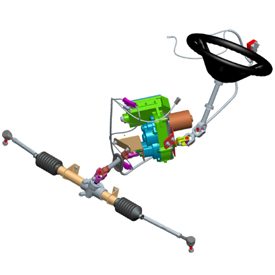 Electric power-assist steering system
Electric power-assist steering system

Electric power-assist steering (EPAS) system has advanced features:
- Anti-kickback feature reduces the amount of steering unwinding when traversing difficult terrain.
- The system is speed sensing and adjusts steering effort as the speed of the vehicle changes.
- As speed increases, there is less steering assist for improved road feel.
- As speed decreases, steering assist increases to give lower steering efforts for improved maneuverability.
- A warning/functional light on the instrument panel provides self-diagnostics and a warning light in the situation of no assist.
- Torque sensor measures steering wheel input so the on-board computer can provide the appropriate output for various driving situations.
With the EPAS system, the operator maintains a direct, mechanical linkage from the steering wheel to the front wheels. The power-steering system interfaces mechanically with the steering system by being inserted between the steering wheel and the rack-and-pinion assembly.
A differential torque sensor is integrated into the power steering assembly. The circuit board assembly is also integral with the power-steering assembly.
Power steering does not reduce turning radius but significantly reduces steering effort by approximately 85 percent compared to those models without power steering.
EPAS interface diagram
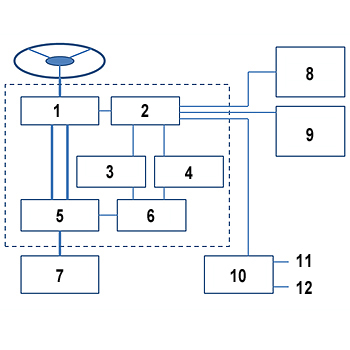 EPAS interface diagram
EPAS interface diagram
The numbered descriptions refer to the EPAS interface diagram shown above:
- Torque sensor
- Engine control unit (ECU)
- Fail-safe relay
- Current/thermal control circuit
- Reduction gears
- DC motor
- Rack and pinion
- Function/warning light
- Key power and ground
- Vehicle speed sensor
- Instrument cluster
- Relay module
Seating for four and rear under-seat storage
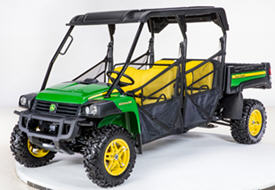 Seating for four
Seating for four
The XUV825M S4 and XUV855M S4 models feature seating for four. The rear seat will convert to provide a flat surface for extra payload and there is sealed under-seat rear storage for additional cargo.
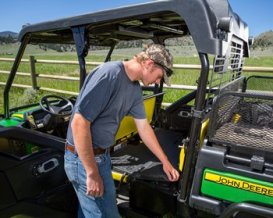 Rear seat down
Rear seat down
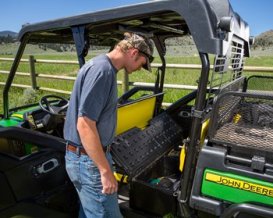 Storage for additional cargo under rear seat
Storage for additional cargo under rear seat
Features
Powerful gas engine delivers superb starting, idling, and throttle response
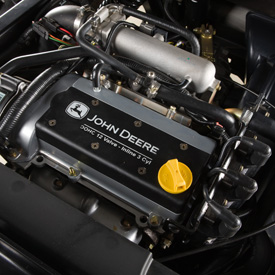 812-cc (49.6-cu in.) gasoline engine
812-cc (49.6-cu in.) gasoline engine
The machine is powered by an 812-cc (49.6-cu in.), 3-cylinder, dual overhead cams, liquid-cooled, four-cycle gasoline engine. It produces 6.5 kgm (47 lb-ft) of torque at 3200 rpm. The advanced electronic controls and fuel-injection system deliver superb starting, idling, and throttle response during operation.
The engine offers the following performance and reliability features:
-
38.8 kW (52 hp*) at 6000 rpm
-
71-km/h (44-mph) top speed
-
Electronic fuel injection for superb performance, altitude adjustment, and cold-weather starting (tested to -28.9°C [-20°F])
-
Electronic ignition is continuously variable for optimum engine power and provides fast, reliable starts
-
Overhead valve design provides greater efficiency and fuel economy
-
Full-pressure lubrication system
-
Spin-on oil filter with drain bracket and oil drain plug enable easy servicing
-
Dry, replaceable, single-element air cleaner with remote intake
-
See-through coolant recovery tank permits the operator to check the coolant level without having to remove the radiator cap
-
Open radiator compartment for air flow
-
-
Standard high-capacity alternator - 85 amps for maximum accessory capability
* The engine horsepower information is provided by the engine manufacturer to be used for comparison purposes only. The actual operating horsepower will be less.
Dual A-arm front and rear suspension provides a smooth ride over challenging terrain and excellent hauling characteristics
 XUV front suspension detail
XUV front suspension detail

To complement the most capable frame available in a high-performance utility vehicle, the XUV is equipped with four-wheel independent suspension.
A dual A-arm front and rear suspension provides a smooth ride over challenging terrain and excellent hauling characteristics.
The entire suspension system has been optimized to handle no cargo to maximum cargo without compromising ride quality or vehicle stability.
Dual A-arm front suspension features include:
-
203.2 mm (8 in.) of travel provides ample compression and wheel extension, which keep all four wheels on the ground for superior traction and vehicle control
-
17.5-mm (0.6875-in.) solid anti-roll bar with fully rubber isolated connecting links and pivots for minimal vehicle body roll and quiet operation
-
Heavy-duty nodular cast-iron knuckles to support the strut, constant-velocity (CV) shaft, and wheel
-
Maintenance-free rubber torsional A-arm pivots for long life and quiet operation
-
CV shaft protection from sticks that may puncture the rubber boot
-
Front sway bear for balanced handling
 XUV rear suspension detail
XUV rear suspension detail

Dual A-arm independent rear suspension features include:
-
Unequal length, dual A-arm construction for superior wheel control and travel
-
228.6 mm (9 in.) of total travel provides ample compression and wheel extension, which keep all four wheels on the ground for superior traction, excellent ride quality, and vehicle control
-
Coil over shocks absorb the most demanding terrain
-
A-arms made from square/rectangular tubing reduce weight while remaining rigid
-
Heavy-duty nodular cast-iron uprights support wheel loads with a double row of ball bearings
-
CV driveshaft protection from sticks that may puncture the rubber boot
Superior terrain capability
The Gator™ XUV Crossover Series Utility Vehicle has a precision-engineered drivetrain system that fully utilizes engine power, optimizing acceleration, hauling, towing, and hill-climbing capabilities. Power is transmitted from the engine through a continuously variable clutch system to the transaxle.
Key elements of the drive system include:
Variable-speed drive
 Variable-speed drive
Variable-speed drive
The variable-speed drive consists of two clutches and a drive belt:
- Drive clutch is attached to the engine.
- Driven clutch is attached to the transaxle.
Features include:
- The engine braking system utilizes a tight belt for operation, requiring an idler sleeve on the primary clutch for neutral. The secondary clutch is a new build on shaft design that utilizes a cam to tune the acceleration and deceleration of the vehicle. The clutch will stay engaged, providing deceleration until approximately 5 km/h (3 mph).
- The Continuously Variable Transmission (CVT™) air intake draws in 50 percent more air vs. previous designs to reduce heat and the amount of water ingestion into the CVT system. The system will reduce belt slipping and improve durability.
- A low- and high-speed forward gear offering:
- Low range is 0 km/h to 43 km/h (0 mph to 27 mph), 825M S4
- Low range is 0 km/h to 24 km/h (0 mph to 15 mph), 855M S4
- High range is 0 km/h to 71 km/h (0 mph to 44 mph), 825M S4
- High range is 0 km/h to 51 km/h (0 mph to 32 mph), 855M S4
- Ability to creep along slowly to maneuver in tight spaces
- Standard full clutch enclosure with high speed fan provides longer belt and clutch life
- High-ratio clutches with three cam weights for maximum belt clamp load in high torque conditions
- Powertrain reduction ratios:
- The complete reduction ratios range for high gear is (8.6:1 at top speed and 42:1 at initial clutch engagement
- The complete reduction ratios range for low gear is (17.9:1 at top speed and 86.8:1 at initial clutch engagement
- NOTE: Delivery and torque to the ground depends on tire size which is a function of nominal size and pressure.
How the variable-speed drive works:
- As engine speed increases, the spring-loaded drive clutch is closed by weights being forced out by centrifugal force.
- As the drive clutch closes, the belt rides up to the largest diameter of the drive clutch and forces open the driven clutch.
- With the belt running in the smallest diameter of the driven clutch, the speed being transferred to the transaxle is increased.
- The driven clutch is designed to sense varying loads (inclines, mud, etc.) and constantly adjusts drive speed upward or downward so that engine rpm remains optimal.
Transaxle, MFWD, and CV shafts
 Side view of CVT intake and clutch on closure (XUV855 shown)
Side view of CVT intake and clutch on closure (XUV855 shown)
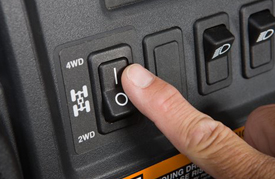 Front differential rocker switch
Front differential rocker switch
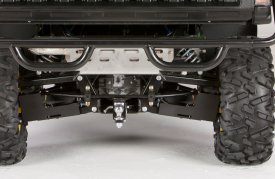 Rear end shot of sway bar, suspension components, and CV shafts (XUV825M S4)
Rear end shot of sway bar, suspension components, and CV shafts (XUV825M S4)
-
Operator interface
-
On-demand true 4WD system with an auto-locking front differential and dash-mounted electronic rocker switch is best-in-class; when the rocker switch is in the on (4WD) position, the front differential will automatically lock for extra traction when needed, but when the rocker switch is in the off (2WD) position, the vehicle will remain in 2WD
-
Provides exceptional traction in challenging conditions
-
Maintains turf-friendly operation in 2WD mode
-
Illuminated for low light operation
-
-
-
Transaxle
-
Two-speed fully enclosed oil bath transaxle allows for superior pulling ability
-
Cast aluminum design is the most robust in the industry
-
Helical forward and reverse gears are used for quiet operation
-
Rear traction assist (differential lock) is built in and can be engaged on demand
-
Allows locking the rear drive wheels together
-
Provides increased traction in tough spots
-
NOTE: Differential design reduces scuffing of the turf during turns because it allows the inside wheels to turn slower than the outside wheels
-
-
Neutral start safety interlock for engine ignition system
-
Large, sealed bearings are located inside the housing for better protection and durability
-
Contains gear case for transferring power to the MFWD
-
Splined shaft interfaces for maximum torque transfer and durability
-
All drive gears machined from highest grade gear steel
-
Protected by a skid plate
-
-
Mechanical front-wheel drive
-
Electronic design is auto-locking for ease of use
-
Performs like a locking differential when engaged, but like an open differential when cornering
-
Offers positive engagement of both front wheels in forward and reverse as a differential package
-
Automatic engagement on the fly—no shift linkages required
-
-
Protected by a skid plate and frame
-
-
Drive shafts
-
Rear CV shaft diameter measures 27 mm (1.1 in.) and designed for peak engine and braking torque
-
Front CV shaft diameter measures 23.9 mm (0.94 in.) and designed for peak engine torque
Propshaft (transaxle to MFWD shaft) diameter measures 23 mm (0.91 in.) and designed for peak engine torque -
All CV Shaft and propshaft joints are maintenance free and protected by exclusive Neoprene boots for durability
-
Extra-durable deluxe cargo box ensures hard-working performance and longevity
 Deluxe cargo box
Deluxe cargo box

The deluxe cargo box consists of a 15 percent glass-filled polypropylene composite material that eliminates rust, dents, and reduces noise.
Deluxe cargo box tailgate
 Tailgate handle
Tailgate handle
 Tailgate lowered to 150 degrees
Tailgate lowered to 150 degrees
The tailgate can be opened or removed for easier cleanout and to carry longer items. The tailgate has been improved, features truck-like performance, and can be operated with one hand.
The standard installed lanyards can also be removed to lower the tailgate to 150 degrees for convenient loading and unloading tasks.
Deluxe cargo box tilt
 Integrated handle for manual cargo-box tilt
Integrated handle for manual cargo-box tilt

The deluxe cargo box is easier to latch, unlatch, raise, and lower with the integrated handle design and gas assist.
A prop rod is provided to hold the box in the upright position for operator convenience, as well as limit box pivot travel.
Integrated tie-down points
 Integrated tie-down point in cargo box bed
Integrated tie-down point in cargo box bed
 Additional tie-down points (TH 6X4 shown)
Additional tie-down points (TH 6X4 shown)
The deluxe cargo box offers integrated tie-down points for increased versatility. Tie down points are located in the following areas:
- Four corners inside the cargo-box bed
- Four points on the load guard directly behind the operator station (A)
- Tie-down bars on either side of the cargo box (B)
- Six points on the underside of the cargo-box frame (circled)
Converting deluxe cargo box to a flat bed
 Deluxe cargo box converted to flat bed (XUV825 shown)
Deluxe cargo box converted to flat bed (XUV825 shown)
The deluxe cargo box easily converts to a flat bed. The flatbed configuration allows loading larger cargo.
Optional accessories
 Brake and taillight with optional protector
Brake and taillight with optional protector
 Bedmat—protects the steel floor from dents
Bedmat—protects the steel floor from dents
 Cargo box power lift
Cargo box power lift

Optional accessories for the deluxe cargo box include:
- Factory-installed brake and taillight
- Factory-installed spray-in liner (not shown)
- Improves skid resistance and surface abrasion protection
- Cargo box bed mat
- Cargo box power lift
Specifications
| Length | 1143 mm (45 in.) |
| Width | 1320 mm (52 in.) |
| Depth | 304 mm (11 in.) |
| Volume | 0.46 m3 (16.4 ft3) |
| Weight capacity | 454 kg (1000 lb) |
| Dump angle | 47 degrees |
CAUTION: Carrying extra-long cargo that extends beyond the box can adversely affect stability.
Equipped with power steering
This Gator™ XUV Crossover Utility Vehicle is equipped with power steering and a dual A-arm front suspension. These automotive-type systems exhibit excellent handling characteristics, as well as responsive steering and low steering effort:
-
Steel ball bearings secure the steering shaft and deliver smooth, responsive operation
-
Completely-sealed rack-and-pinion for long life
- Low steering ratio (lock-to-lock) provides more responsive steering and less operator input
-
Shaft U-joints are phased for a smooth, uninterrupted motion of the steering wheel
 Electric power-assist steering system
Electric power-assist steering system

Electric power-assist steering (EPAS) system has advanced features:
- Anti-kickback feature reduces the amount of steering unwinding when traversing difficult terrain.
- The system is speed sensing and adjusts steering effort as the speed of the vehicle changes.
- As speed increases, there is less steering assist for improved road feel.
- As speed decreases, steering assist increases to give lower steering efforts for improved maneuverability.
- A warning/functional light on the instrument panel provides self-diagnostics and a warning light in the situation of no assist.
- Torque sensor measures steering wheel input so the on-board computer can provide the appropriate output for various driving situations.
With the EPAS system, the operator maintains a direct, mechanical linkage from the steering wheel to the front wheels. The power-steering system interfaces mechanically with the steering system by being inserted between the steering wheel and the rack-and-pinion assembly.
A differential torque sensor is integrated into the power steering assembly. The circuit board assembly is also integral with the power-steering assembly.
Power steering does not reduce turning radius but significantly reduces steering effort by approximately 85 percent compared to those models without power steering.
EPAS interface diagram
 EPAS interface diagram
EPAS interface diagram
The numbered descriptions refer to the EPAS interface diagram shown above:
- Torque sensor
- Engine control unit (ECU)
- Fail-safe relay
- Current/thermal control circuit
- Reduction gears
- DC motor
- Rack and pinion
- Function/warning light
- Key power and ground
- Vehicle speed sensor
- Instrument cluster
- Relay module
Seating for four and rear under-seat storage
 Seating for four
Seating for four
The XUV825M S4 and XUV855M S4 models feature seating for four. The rear seat will convert to provide a flat surface for extra payload and there is sealed under-seat rear storage for additional cargo.
 Rear seat down
Rear seat down
 Storage for additional cargo under rear seat
Storage for additional cargo under rear seat
Features
Delivers quick acceleration and provides a top speed of more than 77 km/h (48 mph)
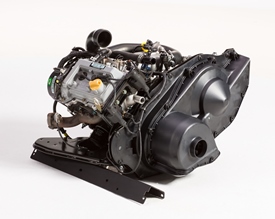 586-cc (35.8-cu in.) gasoline engine
586-cc (35.8-cu in.) gasoline engine
 Radiator
Radiator
The Gator™ XUV590E and XUV590M Crossover Series Utility Vehicle is powered by a 586-cc (35.8-cu in.), inline twin-cylinder, electronic fuel-injected (EFI) gasoline engine. The engine is electronically controlled through an engine control unit (ECU) to ensure optimal engine performance.
The engine offers the following performance and reliability features:
- 23.8 kW (32 hp*) at 5600 rpm
- 77 km/h (48 mph) top speed
- Electronic fuel injection (EFI) with engine control unit (ECU)
- Liquid cooled
- Designed for cold-weather starting (tested to -28.9°C [-20°F])
- Wet-sump lubrication system
- Spin-on oil filter and oil pan drain accessible through skid plate for easy servicing
- High air-flow air filter
- 875-W (65 maximum amp) charging system for accessory capability (see engine section for alternator output curve)
- Spark-arresting muffler is United States Forest Service (USFS) approved
- Low fuel consumption and large 28-L (7.4-U.S. gal.) fuel tank
- Environmental Protection Agency (EPA) and California Air Resources Board (CARB) compliant
* The engine horsepower information is provided by the engine manufacturer to be used for comparison purposes only. The actual operating horsepower will be less.
Designed for all-day comfort with many vehicle conveniences
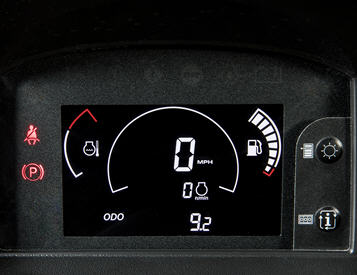 Instrument panel and backlit switches
Instrument panel and backlit switches
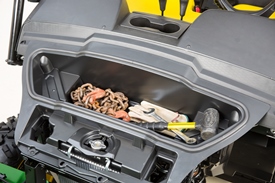 Sealed under-hood storage
Sealed under-hood storage
 Ergonomically placed controls
Ergonomically placed controls
 In-dash cup holders and sealed glove box
In-dash cup holders and sealed glove box
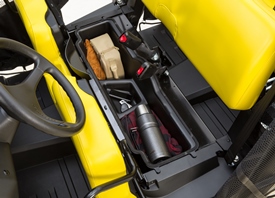 S4 optional under-seat storage
S4 optional under-seat storage
- Operator-centric design provides class-leading ergonomics and comfortable seats
- Easy entry/exit and pass through for operator and passenger
- Optimal seating position provides more legroom
- Automotive-like ergonomics
- Excellent comfort while driving
- Best-in-class sealed storage volume of 34 L (9 gal.) with a large in-dash glove box and under hood storage. An additional 34 L (9 gal.) of under-seat storage is available on the S4 models.
- Hinged hood rotates open without tools for access to storage
- Side-by-side seating provides ample room for one operator and one passenger
- Seats tilt forward for ease of service and to keep dry during outdoor storage
- Two cup holders are located within reach of the operator's station
- Standard 12-V direct current (VDC) outlet is conveniently located on the instrument panel
- Seven predrilled dash switch locations with snap out caps for various electrical accessories
- Occupant protective structure (OPS) with three-point seat belts and passenger side grab handle located on front post
- Start in gear or neutral position for quick starting. The service brake must be engaged to start.
Large, extra-durable, one-piece cargo box ensures hard-driving performance and longevity
The cargo box consists of a high-density polyethylene copolymer composite material that eliminates rust, dents, and reduces noise. This large, one-piece design has rounded inside corners to ensure material removal when tilted. The composite box is highly ribbed and supported with a welded, steel-ladder structure to ensure hard-driving performance and longevity. The three highly-styled exterior pieces are made of TPO for extra durability.
Cargo box tailgate
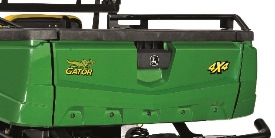 Tailgate handle
Tailgate handle
 Tailgate pivot and removal feature
Tailgate pivot and removal feature
 Removable lanyards
Removable lanyards
The tailgate can be opened or removed for easier cleanout and to carry longer items. It features truck-like performance and can be operated with one hand.
The tailgate’s pivot point is made of hardened steel for durability and designed for tool-free removal. The standard lanyards can also be disconnected without tools to remove the tailgate for convenient loading and unloading tasks.
Cargo box tilt and removal
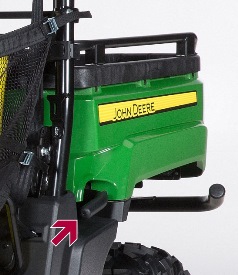 Integrated handle for manual cargo box tilt (both sides)
Integrated handle for manual cargo box tilt (both sides)
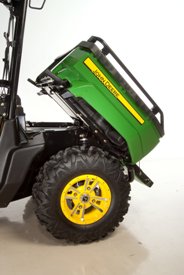 Tilted cargo box
Tilted cargo box
The cargo box ease of use is critical to performing tasks quickly and efficiently. Starting with the truck-style tailgate, the removal of content in this cargo box could not be easier. The manual release also functions as the lift lever, done in a smooth, one-step motion. It can even be tilted from both sides of the vehicle. To reduce the overall effort of lift, the pivot point of the cargo box is closer to the center. The combination of easy-to-use attributes makes this cargo box best-in-class.
For servicing the vehicle’s systems, the cargo box is easily removable. With the removal of two bolts, the cargo box can easily be detached from the vehicle frame.
Integrated tie-down points
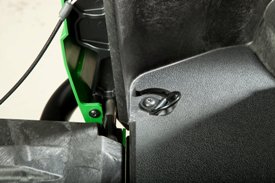 Integrated tie-down point in cargo box bed
Integrated tie-down point in cargo box bed
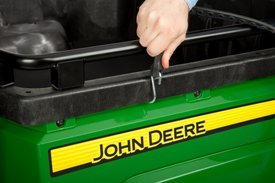 Additional tie-down points
Additional tie-down points
The cargo box offers integrated tie-down points for increased versatility. Tie-down points are located in the following areas:
- Flip-up D-shaped rings in all four corners inside the cargo box bed
- Multiple points along the edge of the cargo box side walls
- Tie-down bars on either side of the cargo box with optional cargo box rail kit. This kit also provides a mounting system using accessories that possess the 25.4-mm (1-in.) quick clamp.
Optional accessories
 Cargo box rail system
Cargo box rail system
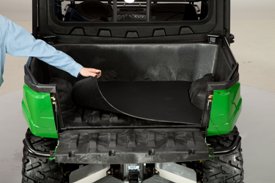 Box mat
Box mat
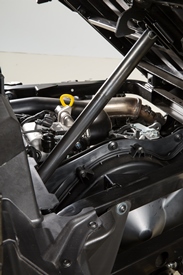 Cargo box power lift
Cargo box power lift
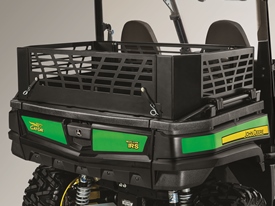 Cargo box wall extensions (shown on RSX)
Cargo box wall extensions (shown on RSX)
Optional accessories for the cargo box include (see price pages or JDConfigurator for complete list):
- Cargo box rail system
- Cargo box mat
- Cargo box power lift
- Cargo box wall extensions
- Spare tire rack
- Bucket holder
Specifications
| Length | 82 cm (32.3 in.) |
| Width | 120.9 cm (47.6 in.) |
| Depth | 29.7 cm (11.7 in.) |
| Volume | 0.25 m3 (8.9 cu ft) |
| Weight capacity | 227 kg (500 lb) |
| Dump angle Bed height (from ground) |
45 degrees 76.3 cm (30 in.) |
CAUTION: Carrying extra-long cargo that extends beyond the box can adversely affect stability.
Four-wheel independent suspension provides unparalleled ride over challenging terrain and excellent handling through corners
 XUV front suspension detail
XUV front suspension detail
To complement the comfortable operation station, the XUV560 and XUV590 Series are equipped with four-wheel independent suspension. This unique suspension set-up provides an unparalleled ride over challenging terrain and excellent handling through corners.
The engineering team, in collaboration with engineering firms that consult with Formula 1®, NASCAR®, and INDYCAR® teams, built a capable suspension system for class-leading operator comfort no matter what the terrain.
Dual A-arm front suspension features include:
- Dual, wide arch A-arm design provides maximum front-wheel control, precise steering, and maximum ground clearance out to the wheel
- 203 mm (8 in.) of travel provides ample compression and wheel extension, which keep all four wheels on the ground for superior traction and vehicle control
- Adjustable coil-over shocks absorb the most demanding terrain
- Solid anti-roll bar with fully rubber isolated connecting links and pivots is tuned to provide the most agile and predictable handling
- Camber during compression to compensate for body roll and to maintain an optimal tire contact patch for improved cornering grip
- Increasing vehicle width during compression for additional stability.
- High-strength ASTM 80-55-06 ductile cast-iron knuckle and upper A-arm to support the high stresses of the shocks, constant-velocity (CV) shaft, and wheels
- Automotive-style, fully boxed and welded, high-strength steel, lower A-arms to minimize unsprung mass and maximize strength
- Maintenance-free, rubber torsional A-arm pivots for long life and quiet operation
- CV shaft protection from sticks that may puncture the rubber boot
- Anti-dive front suspension geometry provides a solid platform for confident braking
- Optimized steering geometry using ADAMS CAR simulation to minimize steering effort and maximize terrain feedback
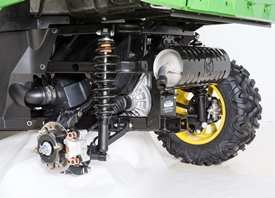 XUV rear suspension detail
XUV rear suspension detail
Independent rear suspension features include:
- 203 mm (8 in.) of travel provides ample compression and wheel extension, which keep all four wheels on the ground for superior traction and vehicle control
- Unique, independent rear-suspension design ensures a great ride and protection for the CV shafts
- Adjustable coil-over shocks absorb the most demanding terrain
- Camber during compression to compensate for body roll and to maintain an optimal tire contact patch for improved cornering grip
- Increasing vehicle width during compression for additional stability.
- High-strength ASTM 80-55-06 ductile cast-iron knuckle, lower A-arm, and upper link to support the high stresses of the shocks, CV shaft, and wheels with the toughness to survive impacts from boulders
- Maintenance-free rubber torsional A-arm pivots for long life and quiet operation
Optional Fox™ Shocks are available to factory install
Exclusive aluminum-body, high-pressure monotube FOX racing shocks
- Fully adjustable spring preload for different driving styles
- High-pressure nitrogen gas is separated from the damping oil by an internal floating piston (IFP). The separation prevents aeration (frothing) and viscosity degradation of the oil which improves damping consistency and performance fade.
- Pressure and heat generation in the monotube is less than a traditional twin-tube shock, allowing for better vehicle control in aggressive conditions.
- The single aluminum shell of the monotube design allows for more efficient heat rejection and lower overall unsprung mass.
- Mounting the shaft end of the shock to the suspension arm lowers the unsprung mass of the suspension system, leading to improved suspension response.
NASCAR is a trademark of NASCAR. INDYCAR is a trademark of Brickyard Trademarks Incorporated. Formula 1 is a trademark of Formula One Licensing BV, a Formula One Group Company.
Power steering for excellent handling characteristics and low steering effort
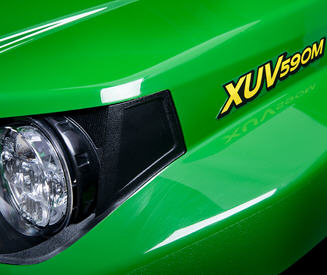 XUV590M with power steering
XUV590M with power steering
The Gator™ XUV590M Utility Vehicles are equipped with rack and pinion steering with power steering. These automotive-type systems exhibit excellent handling characteristics, as well as responsive steering and low steering effort.
Automotive-type, rack-and-pinion steering features include:
Optional electric power-assist steering (EPAS) system. Features of EPAS include:
- Anti-kickback feature reduces the amount of steering unwinding when traversing difficult terrain.
- The system is speed sensing and adjusts steering effort as the speed of the vehicle changes.
- As speed increases there is less steering assist for improved road feel.
- As speed decreases steering assist increases to give lower steering efforts for improved maneuverability.
- A warning/functional light on the instrument panel provides self-diagnostics and a warning light in the situation of no assist.
- Torque sensor measures steering wheel input so the on-board computer can provide the appropriate output for various driving situations.
- Steel ball-bearings secure the steering shaft and delivers smooth, responsive operation
- Tight turn radius of 3.7 m (12.3 ft) for excellent maneuverability
- Completely sealed rack-and-pinion for long life
- Low steering ratio (lock-to-lock steering wheel rotations) provides more responsive steering and less operator input
- Shaft U-joints are phased for a smooth, uninterrupted motion of the steering wheel
- Ackerman steering design provides more responsive steering, decreases tire wear when used on hard surfaces and is turf friendly (see description below)
- Minimal bump steer eliminates unintended vehicle direction changes when traversing terrain and permits less feedback to the steering wheel (see description below)
The tire scrubbing, which also creates unwanted heat and wear in the tire, can be eliminated by turning the inside wheel at a greater angle than the outside one (Ackerman steering).
NOTE: Some competitors use parallel steering instead of Ackerman steering.
Bump steering defines the change in the forward steering angle (thus wheel position) as the suspension travels through its full motion. A large amount of angular change (5 degrees to 7 degrees) will alter the vehicle's direction and excessively move the steering wheel.
Convertible cargo rack design offers additional cargo volume
The exclusive, convertible cargo rack design offers rear seating for two passengers and with a flip of a lever, expands the cargo capacity of the XUV560 S4 and XUV590 S4 by 48 percent.
The convertible cargo rack design offers the ultimate in flexibility for multi-passenger seating capacity and utility.
The majority of the time a vehicle is only transporting one or two people, but at any given moment a third or fourth passenger may come along. The quick and simple convertible cargo rack can be switched back and forth in seconds with a flip of a lever. It provides comfortable rear seating with choice of ample leg room or 48 percent more cargo capacity.
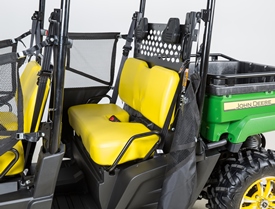 Up position
Up position
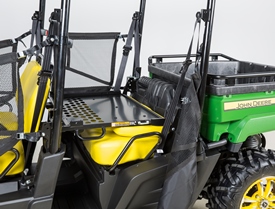 Down position
Down position
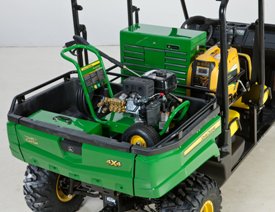 Carrying multiple workshop products
Carrying multiple workshop products
Some key points about the convertible cargo rack:
Offers additional cargo volume of 0.12 m3 (4.3 cu ft) and 90.4-kg (200-lb) capacity.
Efficient one-step conversion from rear seat to cargo rack in 2-3 seconds (and vice-versa) can be easily done by one person
| Length | 59.7 cm (23.5 in.) |
| Width | 98.6 cm (38.8 in.) |
| Depth | 20.6 cm (8.1 in.) |
| Volume | 0.12 m3 (4.3 cu ft) |
| Weight capacity | 90.7 kg (200 lb) |
Features
Delivers quick acceleration and provides a top speed of more than 77 km/h (48 mph)
 586-cc (35.8-cu in.) gasoline engine
586-cc (35.8-cu in.) gasoline engine
 Radiator
Radiator
The Gator™ XUV590E and XUV590M Crossover Series Utility Vehicle is powered by a 586-cc (35.8-cu in.), inline twin-cylinder, electronic fuel-injected (EFI) gasoline engine. The engine is electronically controlled through an engine control unit (ECU) to ensure optimal engine performance.
The engine offers the following performance and reliability features:
- 23.8 kW (32 hp*) at 5600 rpm
- 77 km/h (48 mph) top speed
- Electronic fuel injection (EFI) with engine control unit (ECU)
- Liquid cooled
- Designed for cold-weather starting (tested to -28.9°C [-20°F])
- Wet-sump lubrication system
- Spin-on oil filter and oil pan drain accessible through skid plate for easy servicing
- High air-flow air filter
- 875-W (65 maximum amp) charging system for accessory capability (see engine section for alternator output curve)
- Spark-arresting muffler is United States Forest Service (USFS) approved
- Low fuel consumption and large 28-L (7.4-U.S. gal.) fuel tank
- Environmental Protection Agency (EPA) and California Air Resources Board (CARB) compliant
* The engine horsepower information is provided by the engine manufacturer to be used for comparison purposes only. The actual operating horsepower will be less.
Designed for all-day comfort with many vehicle conveniences
 Instrument panel and backlit switches
Instrument panel and backlit switches
 Sealed under-hood storage
Sealed under-hood storage
 Ergonomically placed controls
Ergonomically placed controls
 In-dash cup holders and sealed glove box
In-dash cup holders and sealed glove box
 S4 optional under-seat storage
S4 optional under-seat storage
- Operator-centric design provides class-leading ergonomics and comfortable seats
- Easy entry/exit and pass through for operator and passenger
- Optimal seating position provides more legroom
- Automotive-like ergonomics
- Excellent comfort while driving
- Best-in-class sealed storage volume of 34 L (9 gal.) with a large in-dash glove box and under hood storage. An additional 34 L (9 gal.) of under-seat storage is available on the S4 models.
- Hinged hood rotates open without tools for access to storage
- Side-by-side seating provides ample room for one operator and one passenger
- Seats tilt forward for ease of service and to keep dry during outdoor storage
- Two cup holders are located within reach of the operator's station
- Standard 12-V direct current (VDC) outlet is conveniently located on the instrument panel
- Seven predrilled dash switch locations with snap out caps for various electrical accessories
- Occupant protective structure (OPS) with three-point seat belts and passenger side grab handle located on front post
- Start in gear or neutral position for quick starting. The service brake must be engaged to start.
Large, extra-durable, one-piece cargo box ensures hard-driving performance and longevity
The cargo box consists of a high-density polyethylene copolymer composite material that eliminates rust, dents, and reduces noise. This large, one-piece design has rounded inside corners to ensure material removal when tilted. The composite box is highly ribbed and supported with a welded, steel-ladder structure to ensure hard-driving performance and longevity. The three highly-styled exterior pieces are made of TPO for extra durability.
Cargo box tailgate
 Tailgate handle
Tailgate handle
 Tailgate pivot and removal feature
Tailgate pivot and removal feature
 Removable lanyards
Removable lanyards
The tailgate can be opened or removed for easier cleanout and to carry longer items. It features truck-like performance and can be operated with one hand.
The tailgate’s pivot point is made of hardened steel for durability and designed for tool-free removal. The standard lanyards can also be disconnected without tools to remove the tailgate for convenient loading and unloading tasks.
Cargo box tilt and removal
 Integrated handle for manual cargo box tilt (both sides)
Integrated handle for manual cargo box tilt (both sides)
 Tilted cargo box
Tilted cargo box
The cargo box ease of use is critical to performing tasks quickly and efficiently. Starting with the truck-style tailgate, the removal of content in this cargo box could not be easier. The manual release also functions as the lift lever, done in a smooth, one-step motion. It can even be tilted from both sides of the vehicle. To reduce the overall effort of lift, the pivot point of the cargo box is closer to the center. The combination of easy-to-use attributes makes this cargo box best-in-class.
For servicing the vehicle’s systems, the cargo box is easily removable. With the removal of two bolts, the cargo box can easily be detached from the vehicle frame.
Integrated tie-down points
 Integrated tie-down point in cargo box bed
Integrated tie-down point in cargo box bed
 Additional tie-down points
Additional tie-down points
The cargo box offers integrated tie-down points for increased versatility. Tie-down points are located in the following areas:
- Flip-up D-shaped rings in all four corners inside the cargo box bed
- Multiple points along the edge of the cargo box side walls
- Tie-down bars on either side of the cargo box with optional cargo box rail kit. This kit also provides a mounting system using accessories that possess the 25.4-mm (1-in.) quick clamp.
Optional accessories
 Cargo box rail system
Cargo box rail system
 Box mat
Box mat
 Cargo box power lift
Cargo box power lift
 Cargo box wall extensions (shown on RSX)
Cargo box wall extensions (shown on RSX)
Optional accessories for the cargo box include (see price pages or JDConfigurator for complete list):
- Cargo box rail system
- Cargo box mat
- Cargo box power lift
- Cargo box wall extensions
- Spare tire rack
- Bucket holder
Specifications
| Length | 82 cm (32.3 in.) |
| Width | 120.9 cm (47.6 in.) |
| Depth | 29.7 cm (11.7 in.) |
| Volume | 0.25 m3 (8.9 cu ft) |
| Weight capacity | 227 kg (500 lb) |
| Dump angle Bed height (from ground) |
45 degrees 76.3 cm (30 in.) |
CAUTION: Carrying extra-long cargo that extends beyond the box can adversely affect stability.
Four-wheel independent suspension provides unparalleled ride over challenging terrain and excellent handling through corners
 XUV front suspension detail
XUV front suspension detail
To complement the comfortable operation station, the XUV560 and XUV590 Series are equipped with four-wheel independent suspension. This unique suspension set-up provides an unparalleled ride over challenging terrain and excellent handling through corners.
The engineering team, in collaboration with engineering firms that consult with Formula 1®, NASCAR®, and INDYCAR® teams, built a capable suspension system for class-leading operator comfort no matter what the terrain.
Dual A-arm front suspension features include:
- Dual, wide arch A-arm design provides maximum front-wheel control, precise steering, and maximum ground clearance out to the wheel
- 203 mm (8 in.) of travel provides ample compression and wheel extension, which keep all four wheels on the ground for superior traction and vehicle control
- Adjustable coil-over shocks absorb the most demanding terrain
- Solid anti-roll bar with fully rubber isolated connecting links and pivots is tuned to provide the most agile and predictable handling
- Camber during compression to compensate for body roll and to maintain an optimal tire contact patch for improved cornering grip
- Increasing vehicle width during compression for additional stability.
- High-strength ASTM 80-55-06 ductile cast-iron knuckle and upper A-arm to support the high stresses of the shocks, constant-velocity (CV) shaft, and wheels
- Automotive-style, fully boxed and welded, high-strength steel, lower A-arms to minimize unsprung mass and maximize strength
- Maintenance-free, rubber torsional A-arm pivots for long life and quiet operation
- CV shaft protection from sticks that may puncture the rubber boot
- Anti-dive front suspension geometry provides a solid platform for confident braking
- Optimized steering geometry using ADAMS CAR simulation to minimize steering effort and maximize terrain feedback
 XUV rear suspension detail
XUV rear suspension detail
Independent rear suspension features include:
- 203 mm (8 in.) of travel provides ample compression and wheel extension, which keep all four wheels on the ground for superior traction and vehicle control
- Unique, independent rear-suspension design ensures a great ride and protection for the CV shafts
- Adjustable coil-over shocks absorb the most demanding terrain
- Camber during compression to compensate for body roll and to maintain an optimal tire contact patch for improved cornering grip
- Increasing vehicle width during compression for additional stability.
- High-strength ASTM 80-55-06 ductile cast-iron knuckle, lower A-arm, and upper link to support the high stresses of the shocks, CV shaft, and wheels with the toughness to survive impacts from boulders
- Maintenance-free rubber torsional A-arm pivots for long life and quiet operation
Optional Fox™ Shocks are available to factory install
Exclusive aluminum-body, high-pressure monotube FOX racing shocks
- Fully adjustable spring preload for different driving styles
- High-pressure nitrogen gas is separated from the damping oil by an internal floating piston (IFP). The separation prevents aeration (frothing) and viscosity degradation of the oil which improves damping consistency and performance fade.
- Pressure and heat generation in the monotube is less than a traditional twin-tube shock, allowing for better vehicle control in aggressive conditions.
- The single aluminum shell of the monotube design allows for more efficient heat rejection and lower overall unsprung mass.
- Mounting the shaft end of the shock to the suspension arm lowers the unsprung mass of the suspension system, leading to improved suspension response.
NASCAR is a trademark of NASCAR. INDYCAR is a trademark of Brickyard Trademarks Incorporated. Formula 1 is a trademark of Formula One Licensing BV, a Formula One Group Company.
Convertible cargo rack design offers additional cargo volume
The exclusive, convertible cargo rack design offers rear seating for two passengers and with a flip of a lever, expands the cargo capacity of the XUV560 S4 and XUV590 S4 by 48 percent.
The convertible cargo rack design offers the ultimate in flexibility for multi-passenger seating capacity and utility.
The majority of the time a vehicle is only transporting one or two people, but at any given moment a third or fourth passenger may come along. The quick and simple convertible cargo rack can be switched back and forth in seconds with a flip of a lever. It provides comfortable rear seating with choice of ample leg room or 48 percent more cargo capacity.
 Up position
Up position
 Down position
Down position
 Carrying multiple workshop products
Carrying multiple workshop products
Some key points about the convertible cargo rack:
Offers additional cargo volume of 0.12 m3 (4.3 cu ft) and 90.4-kg (200-lb) capacity.
Efficient one-step conversion from rear seat to cargo rack in 2-3 seconds (and vice-versa) can be easily done by one person
| Length | 59.7 cm (23.5 in.) |
| Width | 98.6 cm (38.8 in.) |
| Depth | 20.6 cm (8.1 in.) |
| Volume | 0.12 m3 (4.3 cu ft) |
| Weight capacity | 90.7 kg (200 lb) |
Features
Delivers quick acceleration and provides a top speed of 28 mph (45 km/h)
 Powertrain 34.8 cu in. (570-cm3) gasoline engine
Powertrain 34.8 cu in. (570-cm3) gasoline engine
The Gator™ XUV560E Crossover Series Utility Vehicles are powered by a 34.8 cu in. (570-cm3), V-twin gasoline engine. The carburetor is tuned for rapid throttle response, reliable cold-weather starting, smooth mid-range power delivery and quiet idling.
The engine offers the following performance and reliability features:
- 11.9 kW (16 hp*) at 3600 rpm
- Tuned to deliver 0 to 24.1 km/h (0 to 15 mph) acceleration in 3.5 seconds
- 45 km/h (28 mph) top speed
- Dynamically tuned carburetor for rapid throttle response upon demand while allowing the engine to burn clean under light loads.
- V-twin, 90-degree overhead valve design maximizes power and torque and provides longer valve life
- Designed for cold-weather starting (tested to -20°F [-28.9°C])
- Full-pressure lubrication system
- Spin-on oil filter with drain bracket and oil drain valve enable easy servicing
- High air-flow air filter
- Laminated and contoured engine blower housing cuts noise levels while reducing oil temperatures 25-30 degrees
- T6 heat-treated aluminum alloy connecting rods and piston ring package
- 200 -W(16 maximum amp) stator charging system for accessory capability
- Dual-header pipe to muffler maximizes airflow and provides a unique V-twin sound
- Spark-arresting muffler is United States Forest Service (USFS) approved
- Low fuel consumption and large 4.9-U.S. gal. (18.9-L) fuel tank
- Environmental Protection Agency (EPA) and California Air Resources Board (CARB) compliant
* The engine horsepower information is provided by the engine manufacturer to be used for comparison purposes only. The actual operating horsepower will be less.
Designed for all-day comfort with many vehicle conveniences
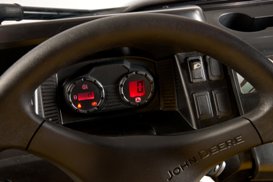 Instrument cluster, optional speedometer, and back-lit switches
Instrument cluster, optional speedometer, and back-lit switches
 Sealed under-hood storage
Sealed under-hood storage
 In-dash cup holders and sealed glove box
In-dash cup holders and sealed glove box
 S4 optional under-seat storage
S4 optional under-seat storage
- Operator-centric design provides class-leading ergonomics and comfortable seats
- Easy entry/exit and pass through for operator and passenger
- Optimal seating position provides more legroom
- Automotive-like ergonomics
- Excellent comfort while driving
- Best-in-class sealed storage volume of 12.7 gal. (48 L) with a large in-dash glove box and under hood storage. An additional 9 gal. (34 L) of under-seat storage is available on the S4 models.
- Hinged hood rotates open without tools for access to storage
- Side-by-side seating provides ample room for one operator and one passenger
- Seats tilt forward for ease of service and to keep dry during outdoor storage
- Two cup holders are located within reach of the operator's station
- Hour-meter comes standard to assist in maintaining regular service intervals
- Standard 12-V direct current (VDC) outlet is conveniently located on the instrument panel
- Seven predrilled dash switch locations with snap out caps for various electrical accessories
- Fuel gauge that can be viewed from the operator's seat
- Occupant protective structure (OPS) with three-point seat belts and passenger side grab handles located on front post
- Start in gear or neutral position for quick starting. The service brake must be engaged to start.
Large, extra-durable, one-piece cargo box ensures hard-driving performance and longevity
The cargo box consists of a high-density polyethylene copolymer composite material that eliminates rust, dents, and reduces noise. This large, one-piece design has rounded inside corners to ensure material removal when tilted. The composite box is highly ribbed and supported with a welded, steel-ladder structure to ensure hard-driving performance and longevity. The three highly-styled exterior pieces are made of TPO for extra durability.
Cargo box tailgate
 Tailgate handle
Tailgate handle
 Tailgate pivot and removal feature
Tailgate pivot and removal feature
 Removable lanyards
Removable lanyards
The tailgate can be opened or removed for easier cleanout and to carry longer items. It features truck-like performance and can be operated with one hand.
The tailgate’s pivot point is made of hardened steel for durability and designed for tool-free removal. The standard lanyards can also be disconnected without tools to remove the tailgate for convenient loading and unloading tasks.
Cargo box tilt and removal
 Integrated handle for manual cargo box tilt (both sides)
Integrated handle for manual cargo box tilt (both sides)
 Tilted cargo box
Tilted cargo box
The cargo box ease of use is critical to performing tasks quickly and efficiently. Starting with the truck-style tailgate, the removal of content in this cargo box could not be easier. The manual release also functions as the lift lever, done in a smooth, one-step motion. It can even be tilted from both sides of the vehicle. To reduce the overall effort of lift, the pivot point of the cargo box is closer to the center. The combination of easy-to-use attributes makes this cargo box best-in-class.
For servicing the vehicle’s systems, the cargo box is easily removable. With the removal of two bolts, the cargo box can easily be detached from the vehicle frame.
Integrated tie-down points
 Integrated tie-down point in cargo box bed
Integrated tie-down point in cargo box bed
 Additional tie-down points
Additional tie-down points
The cargo box offers integrated tie-down points for increased versatility. Tie-down points are located in the following areas:
- Flip-up D-shaped rings in all four corners inside the cargo box bed
- Multiple points along the edge of the cargo box side walls
- Tie-down bars on either side of the cargo box with optional cargo box rail kit. This kit also provides a mounting system using accessories that possess the 25.4-mm (1-in.) quick clamp.
Optional accessories
 Cargo box rail system
Cargo box rail system
 Box mat
Box mat
 Cargo box power lift
Cargo box power lift
 Cargo box wall extensions (shown on RSX)
Cargo box wall extensions (shown on RSX)
Optional accessories for the cargo box include (see price pages or JDConfigurator for complete list):
- Cargo box rail system
- Cargo box mat
- Cargo box power lift
- Cargo box wall extensions
- Spare tire rack
- Bucket holder
Specifications
| Length | 82 cm (32.3 in.) |
| Width | 120.9 cm (47.6 in.) |
| Depth | 29.7 cm (11.7 in.) |
| Volume | 0.25 m3 (8.9 cu ft) |
| Weight capacity | 227 kg (500 lb) |
| Dump angle Bed height (from ground) |
45 degrees 76.3 cm (30 in.) |
CAUTION: Carrying extra-long cargo that extends beyond the box can adversely affect stability.
Four-wheel independent suspension provides unparalleled ride over challenging terrain and excellent handling through corners
 XUV front suspension detail
XUV front suspension detail
To complement the comfortable operation station, the XUV560 and XUV590 Series are equipped with four-wheel independent suspension. This unique suspension set-up provides an unparalleled ride over challenging terrain and excellent handling through corners.
The engineering team, in collaboration with engineering firms that consult with Formula 1®, NASCAR®, and INDYCAR® teams, built a capable suspension system for class-leading operator comfort no matter what the terrain.
Dual A-arm front suspension features include:
- Dual, wide arch A-arm design provides maximum front-wheel control, precise steering, and maximum ground clearance out to the wheel
- 203 mm (8 in.) of travel provides ample compression and wheel extension, which keep all four wheels on the ground for superior traction and vehicle control
- Adjustable coil-over shocks absorb the most demanding terrain
- Solid anti-roll bar with fully rubber isolated connecting links and pivots is tuned to provide the most agile and predictable handling
- Camber during compression to compensate for body roll and to maintain an optimal tire contact patch for improved cornering grip
- Increasing vehicle width during compression for additional stability.
- High-strength ASTM 80-55-06 ductile cast-iron knuckle and upper A-arm to support the high stresses of the shocks, constant-velocity (CV) shaft, and wheels
- Automotive-style, fully boxed and welded, high-strength steel, lower A-arms to minimize unsprung mass and maximize strength
- Maintenance-free, rubber torsional A-arm pivots for long life and quiet operation
- CV shaft protection from sticks that may puncture the rubber boot
- Anti-dive front suspension geometry provides a solid platform for confident braking
- Optimized steering geometry using ADAMS CAR simulation to minimize steering effort and maximize terrain feedback
 XUV rear suspension detail
XUV rear suspension detail
Independent rear suspension features include:
- 203 mm (8 in.) of travel provides ample compression and wheel extension, which keep all four wheels on the ground for superior traction and vehicle control
- Unique, independent rear-suspension design ensures a great ride and protection for the CV shafts
- Adjustable coil-over shocks absorb the most demanding terrain
- Camber during compression to compensate for body roll and to maintain an optimal tire contact patch for improved cornering grip
- Increasing vehicle width during compression for additional stability.
- High-strength ASTM 80-55-06 ductile cast-iron knuckle, lower A-arm, and upper link to support the high stresses of the shocks, CV shaft, and wheels with the toughness to survive impacts from boulders
- Maintenance-free rubber torsional A-arm pivots for long life and quiet operation
Optional Fox™ Shocks are available to factory install
Exclusive aluminum-body, high-pressure monotube FOX racing shocks
- Fully adjustable spring preload for different driving styles
- High-pressure nitrogen gas is separated from the damping oil by an internal floating piston (IFP). The separation prevents aeration (frothing) and viscosity degradation of the oil which improves damping consistency and performance fade.
- Pressure and heat generation in the monotube is less than a traditional twin-tube shock, allowing for better vehicle control in aggressive conditions.
- The single aluminum shell of the monotube design allows for more efficient heat rejection and lower overall unsprung mass.
- Mounting the shaft end of the shock to the suspension arm lowers the unsprung mass of the suspension system, leading to improved suspension response.
NASCAR is a trademark of NASCAR. INDYCAR is a trademark of Brickyard Trademarks Incorporated. Formula 1 is a trademark of Formula One Licensing BV, a Formula One Group Company.
Convertible cargo rack design offers additional cargo volume
The exclusive, convertible cargo rack design offers rear seating for two passengers and with a flip of a lever, expands the cargo capacity of the XUV560 S4 and XUV590 S4 by 48 percent.
The convertible cargo rack design offers the ultimate in flexibility for multi-passenger seating capacity and utility.
The majority of the time a vehicle is only transporting one or two people, but at any given moment a third or fourth passenger may come along. The quick and simple convertible cargo rack can be switched back and forth in seconds with a flip of a lever. It provides comfortable rear seating with choice of ample leg room or 48 percent more cargo capacity.
 Up position
Up position
 Down position
Down position
 Carrying multiple workshop products
Carrying multiple workshop products
Some key points about the convertible cargo rack:
Offers additional cargo volume of 0.12 m3 (4.3 cu ft) and 90.4-kg (200-lb) capacity.
Efficient one-step conversion from rear seat to cargo rack in 2-3 seconds (and vice-versa) can be easily done by one person
| Length | 59.7 cm (23.5 in.) |
| Width | 98.6 cm (38.8 in.) |
| Depth | 20.6 cm (8.1 in.) |
| Volume | 0.12 m3 (4.3 cu ft) |
| Weight capacity | 90.7 kg (200 lb) |
Features
Special Edition Package
Special Edition comes loaded with added attachments and features

The Gator™ XUV590M Special Edition Utility Vehicles comes with the following features and attachments:
- XUV590M Special Edition comes in high-gloss black with Special Edition graphics
 High-gloss black with silver model decals
High-gloss black with silver model decals
 Special Edition dash decal
Special Edition dash decal
- 66-cm (26-in.) Maxxis® Bighorn® tires on 35.6-cm (14-in.) aluminum black alloy wheels
 Maxxis Bighorn tires on black aluminum alloys
Maxxis Bighorn tires on black aluminum alloys
- FOX monotube racing shocks for a smooth ride
 FOX monotube racing shocks
FOX monotube racing shocks
Sport steering wheel with silver color accents and easy-to-grip design
 Sport steering wheel
Sport steering wheel
Occupant side retention (OSR) half doors and Special Edition Gator closeout panel for a customized look
 OSR half door with custom Special Edition Gator closeout panel
OSR half door with custom Special Edition Gator closeout panel
Utility and protection package including poly roof, brush guard, cargo box rails, rear bumper, and floor mats
 Poly roof, brush guard
Poly roof, brush guard
 Rear bumper, cargo box rails
Rear bumper, cargo box rails
 Floor mats
Floor mats
1587.6-kg (3500-lb) WARN® winch with 5.1-cm (2-in.) front receiver and recovery loops
 3500 lb WARN winch with front receiver and recovery loops
3500 lb WARN winch with front receiver and recovery loops
Maxxis and Bighorn are Cheng Shin Rubber Ind. Co., Ltd. FOX is a trademark of FOX Factory, Inc. WARN is a trademark of WARN Industries, Inc.
Occupant protective structure (OPS) and occupant side retention (OSR)
 XUV590 with OSR nets
XUV590 with OSR nets
A dynamically stable vehicle starts with the architectural design; the Gator™ XUV Crossover Series has a low center of gravity, a wide stance, and balance of weight between the front and rear axles.
The combination leads to a class-leading static stability factor (SSF) and passing a multitude of dynamic stability tests.
OPS
 Standard OPS
Standard OPS
Standard OPS with three-point seat belts and OSR nets are shown on the XUV560E.
The OPS is Society of Automotive Engineers (SAE) J2194 certified.
OSR
 OSR nets (available on XUV560 & XUV590)
OSR nets (available on XUV560 & XUV590)
 OSR doors (compatible with all XUV590 two-passenger models)
OSR doors (compatible with all XUV590 two-passenger models)
Meets American Nation Standards Institute (ANSI) B71.9 certification
- One-handed operation
- Easy entry/exit
- Great visibility
Features
Delivers quick acceleration and provides a top speed of more than 77 km/h (48 mph)
 586-cc (35.8-cu in.) gasoline engine
586-cc (35.8-cu in.) gasoline engine
 Radiator
Radiator
The Gator™ XUV590E and XUV590M Crossover Series Utility Vehicle is powered by a 586-cc (35.8-cu in.), inline twin-cylinder, electronic fuel-injected (EFI) gasoline engine. The engine is electronically controlled through an engine control unit (ECU) to ensure optimal engine performance.
The engine offers the following performance and reliability features:
- 23.8 kW (32 hp*) at 5600 rpm
- 77 km/h (48 mph) top speed
- Electronic fuel injection (EFI) with engine control unit (ECU)
- Liquid cooled
- Designed for cold-weather starting (tested to -28.9°C [-20°F])
- Wet-sump lubrication system
- Spin-on oil filter and oil pan drain accessible through skid plate for easy servicing
- High air-flow air filter
- 875-W (65 maximum amp) charging system for accessory capability (see engine section for alternator output curve)
- Spark-arresting muffler is United States Forest Service (USFS) approved
- Low fuel consumption and large 28-L (7.4-U.S. gal.) fuel tank
- Environmental Protection Agency (EPA) and California Air Resources Board (CARB) compliant
* The engine horsepower information is provided by the engine manufacturer to be used for comparison purposes only. The actual operating horsepower will be less.
Designed for all-day comfort with many vehicle conveniences
 Instrument panel and backlit switches
Instrument panel and backlit switches
 Sealed under-hood storage
Sealed under-hood storage
 Ergonomically placed controls
Ergonomically placed controls
 In-dash cup holders and sealed glove box
In-dash cup holders and sealed glove box
 S4 optional under-seat storage
S4 optional under-seat storage
- Operator-centric design provides class-leading ergonomics and comfortable seats
- Easy entry/exit and pass through for operator and passenger
- Optimal seating position provides more legroom
- Automotive-like ergonomics
- Excellent comfort while driving
- Best-in-class sealed storage volume of 34 L (9 gal.) with a large in-dash glove box and under hood storage. An additional 34 L (9 gal.) of under-seat storage is available on the S4 models.
- Hinged hood rotates open without tools for access to storage
- Side-by-side seating provides ample room for one operator and one passenger
- Seats tilt forward for ease of service and to keep dry during outdoor storage
- Two cup holders are located within reach of the operator's station
- Standard 12-V direct current (VDC) outlet is conveniently located on the instrument panel
- Seven predrilled dash switch locations with snap out caps for various electrical accessories
- Occupant protective structure (OPS) with three-point seat belts and passenger side grab handle located on front post
- Start in gear or neutral position for quick starting. The service brake must be engaged to start.
Large, extra-durable, one-piece cargo box ensures hard-driving performance and longevity
The cargo box consists of a high-density polyethylene copolymer composite material that eliminates rust, dents, and reduces noise. This large, one-piece design has rounded inside corners to ensure material removal when tilted. The composite box is highly ribbed and supported with a welded, steel-ladder structure to ensure hard-driving performance and longevity. The three highly-styled exterior pieces are made of TPO for extra durability.
Cargo box tailgate
 Tailgate handle
Tailgate handle
 Tailgate pivot and removal feature
Tailgate pivot and removal feature
 Removable lanyards
Removable lanyards
The tailgate can be opened or removed for easier cleanout and to carry longer items. It features truck-like performance and can be operated with one hand.
The tailgate’s pivot point is made of hardened steel for durability and designed for tool-free removal. The standard lanyards can also be disconnected without tools to remove the tailgate for convenient loading and unloading tasks.
Cargo box tilt and removal
 Integrated handle for manual cargo box tilt (both sides)
Integrated handle for manual cargo box tilt (both sides)
 Tilted cargo box
Tilted cargo box
The cargo box ease of use is critical to performing tasks quickly and efficiently. Starting with the truck-style tailgate, the removal of content in this cargo box could not be easier. The manual release also functions as the lift lever, done in a smooth, one-step motion. It can even be tilted from both sides of the vehicle. To reduce the overall effort of lift, the pivot point of the cargo box is closer to the center. The combination of easy-to-use attributes makes this cargo box best-in-class.
For servicing the vehicle’s systems, the cargo box is easily removable. With the removal of two bolts, the cargo box can easily be detached from the vehicle frame.
Integrated tie-down points
 Integrated tie-down point in cargo box bed
Integrated tie-down point in cargo box bed
 Additional tie-down points
Additional tie-down points
The cargo box offers integrated tie-down points for increased versatility. Tie-down points are located in the following areas:
- Flip-up D-shaped rings in all four corners inside the cargo box bed
- Multiple points along the edge of the cargo box side walls
- Tie-down bars on either side of the cargo box with optional cargo box rail kit. This kit also provides a mounting system using accessories that possess the 25.4-mm (1-in.) quick clamp.
Optional accessories
 Cargo box rail system
Cargo box rail system
 Box mat
Box mat
 Cargo box power lift
Cargo box power lift
 Cargo box wall extensions (shown on RSX)
Cargo box wall extensions (shown on RSX)
Optional accessories for the cargo box include (see price pages or JDConfigurator for complete list):
- Cargo box rail system
- Cargo box mat
- Cargo box power lift
- Cargo box wall extensions
- Spare tire rack
- Bucket holder
Specifications
| Length | 82 cm (32.3 in.) |
| Width | 120.9 cm (47.6 in.) |
| Depth | 29.7 cm (11.7 in.) |
| Volume | 0.25 m3 (8.9 cu ft) |
| Weight capacity | 227 kg (500 lb) |
| Dump angle Bed height (from ground) |
45 degrees 76.3 cm (30 in.) |
CAUTION: Carrying extra-long cargo that extends beyond the box can adversely affect stability.
Four-wheel independent suspension provides unparalleled ride over challenging terrain and excellent handling through corners
 XUV front suspension detail
XUV front suspension detail
To complement the comfortable operation station, the XUV560 and XUV590 Series are equipped with four-wheel independent suspension. This unique suspension set-up provides an unparalleled ride over challenging terrain and excellent handling through corners.
The engineering team, in collaboration with engineering firms that consult with Formula 1®, NASCAR®, and INDYCAR® teams, built a capable suspension system for class-leading operator comfort no matter what the terrain.
Dual A-arm front suspension features include:
- Dual, wide arch A-arm design provides maximum front-wheel control, precise steering, and maximum ground clearance out to the wheel
- 203 mm (8 in.) of travel provides ample compression and wheel extension, which keep all four wheels on the ground for superior traction and vehicle control
- Adjustable coil-over shocks absorb the most demanding terrain
- Solid anti-roll bar with fully rubber isolated connecting links and pivots is tuned to provide the most agile and predictable handling
- Camber during compression to compensate for body roll and to maintain an optimal tire contact patch for improved cornering grip
- Increasing vehicle width during compression for additional stability.
- High-strength ASTM 80-55-06 ductile cast-iron knuckle and upper A-arm to support the high stresses of the shocks, constant-velocity (CV) shaft, and wheels
- Automotive-style, fully boxed and welded, high-strength steel, lower A-arms to minimize unsprung mass and maximize strength
- Maintenance-free, rubber torsional A-arm pivots for long life and quiet operation
- CV shaft protection from sticks that may puncture the rubber boot
- Anti-dive front suspension geometry provides a solid platform for confident braking
- Optimized steering geometry using ADAMS CAR simulation to minimize steering effort and maximize terrain feedback
 XUV rear suspension detail
XUV rear suspension detail
Independent rear suspension features include:
- 203 mm (8 in.) of travel provides ample compression and wheel extension, which keep all four wheels on the ground for superior traction and vehicle control
- Unique, independent rear-suspension design ensures a great ride and protection for the CV shafts
- Adjustable coil-over shocks absorb the most demanding terrain
- Camber during compression to compensate for body roll and to maintain an optimal tire contact patch for improved cornering grip
- Increasing vehicle width during compression for additional stability.
- High-strength ASTM 80-55-06 ductile cast-iron knuckle, lower A-arm, and upper link to support the high stresses of the shocks, CV shaft, and wheels with the toughness to survive impacts from boulders
- Maintenance-free rubber torsional A-arm pivots for long life and quiet operation
Optional Fox™ Shocks are available to factory install
Exclusive aluminum-body, high-pressure monotube FOX racing shocks
- Fully adjustable spring preload for different driving styles
- High-pressure nitrogen gas is separated from the damping oil by an internal floating piston (IFP). The separation prevents aeration (frothing) and viscosity degradation of the oil which improves damping consistency and performance fade.
- Pressure and heat generation in the monotube is less than a traditional twin-tube shock, allowing for better vehicle control in aggressive conditions.
- The single aluminum shell of the monotube design allows for more efficient heat rejection and lower overall unsprung mass.
- Mounting the shaft end of the shock to the suspension arm lowers the unsprung mass of the suspension system, leading to improved suspension response.
NASCAR is a trademark of NASCAR. INDYCAR is a trademark of Brickyard Trademarks Incorporated. Formula 1 is a trademark of Formula One Licensing BV, a Formula One Group Company.
Power steering for excellent handling characteristics and low steering effort
 XUV590M with power steering
XUV590M with power steering
The Gator™ XUV590M Utility Vehicles are equipped with rack and pinion steering with power steering. These automotive-type systems exhibit excellent handling characteristics, as well as responsive steering and low steering effort.
Automotive-type, rack-and-pinion steering features include:
Optional electric power-assist steering (EPAS) system. Features of EPAS include:
- Anti-kickback feature reduces the amount of steering unwinding when traversing difficult terrain.
- The system is speed sensing and adjusts steering effort as the speed of the vehicle changes.
- As speed increases there is less steering assist for improved road feel.
- As speed decreases steering assist increases to give lower steering efforts for improved maneuverability.
- A warning/functional light on the instrument panel provides self-diagnostics and a warning light in the situation of no assist.
- Torque sensor measures steering wheel input so the on-board computer can provide the appropriate output for various driving situations.
- Steel ball-bearings secure the steering shaft and delivers smooth, responsive operation
- Tight turn radius of 3.7 m (12.3 ft) for excellent maneuverability
- Completely sealed rack-and-pinion for long life
- Low steering ratio (lock-to-lock steering wheel rotations) provides more responsive steering and less operator input
- Shaft U-joints are phased for a smooth, uninterrupted motion of the steering wheel
- Ackerman steering design provides more responsive steering, decreases tire wear when used on hard surfaces and is turf friendly (see description below)
- Minimal bump steer eliminates unintended vehicle direction changes when traversing terrain and permits less feedback to the steering wheel (see description below)
The tire scrubbing, which also creates unwanted heat and wear in the tire, can be eliminated by turning the inside wheel at a greater angle than the outside one (Ackerman steering).
NOTE: Some competitors use parallel steering instead of Ackerman steering.
Bump steering defines the change in the forward steering angle (thus wheel position) as the suspension travels through its full motion. A large amount of angular change (5 degrees to 7 degrees) will alter the vehicle's direction and excessively move the steering wheel.
Occupant protective structure (OPS) and occupant side retention (OSR)
 XUV590 with OSR nets
XUV590 with OSR nets
A dynamically stable vehicle starts with the architectural design; the Gator™ XUV Crossover Series has a low center of gravity, a wide stance, and balance of weight between the front and rear axles.
The combination leads to a class-leading static stability factor (SSF) and passing a multitude of dynamic stability tests.
OPS
 Standard OPS
Standard OPS
Standard OPS with three-point seat belts and OSR nets are shown on the XUV560E.
The OPS is Society of Automotive Engineers (SAE) J2194 certified.
OSR
 OSR nets (available on XUV560 & XUV590)
OSR nets (available on XUV560 & XUV590)
 OSR doors (compatible with all XUV590 two-passenger models)
OSR doors (compatible with all XUV590 two-passenger models)
Meets American Nation Standards Institute (ANSI) B71.9 certification
- One-handed operation
- Easy entry/exit
- Great visibility
Features
Delivers quick acceleration and provides a top speed of more than 77 km/h (48 mph)
 586-cc (35.8-cu in.) gasoline engine
586-cc (35.8-cu in.) gasoline engine
 Radiator
Radiator
The Gator™ XUV590E and XUV590M Crossover Series Utility Vehicle is powered by a 586-cc (35.8-cu in.), inline twin-cylinder, electronic fuel-injected (EFI) gasoline engine. The engine is electronically controlled through an engine control unit (ECU) to ensure optimal engine performance.
The engine offers the following performance and reliability features:
- 23.8 kW (32 hp*) at 5600 rpm
- 77 km/h (48 mph) top speed
- Electronic fuel injection (EFI) with engine control unit (ECU)
- Liquid cooled
- Designed for cold-weather starting (tested to -28.9°C [-20°F])
- Wet-sump lubrication system
- Spin-on oil filter and oil pan drain accessible through skid plate for easy servicing
- High air-flow air filter
- 875-W (65 maximum amp) charging system for accessory capability (see engine section for alternator output curve)
- Spark-arresting muffler is United States Forest Service (USFS) approved
- Low fuel consumption and large 28-L (7.4-U.S. gal.) fuel tank
- Environmental Protection Agency (EPA) and California Air Resources Board (CARB) compliant
* The engine horsepower information is provided by the engine manufacturer to be used for comparison purposes only. The actual operating horsepower will be less.
Designed for all-day comfort with many vehicle conveniences
 Instrument panel and backlit switches
Instrument panel and backlit switches
 Sealed under-hood storage
Sealed under-hood storage
 Ergonomically placed controls
Ergonomically placed controls
 In-dash cup holders and sealed glove box
In-dash cup holders and sealed glove box
 S4 optional under-seat storage
S4 optional under-seat storage
- Operator-centric design provides class-leading ergonomics and comfortable seats
- Easy entry/exit and pass through for operator and passenger
- Optimal seating position provides more legroom
- Automotive-like ergonomics
- Excellent comfort while driving
- Best-in-class sealed storage volume of 34 L (9 gal.) with a large in-dash glove box and under hood storage. An additional 34 L (9 gal.) of under-seat storage is available on the S4 models.
- Hinged hood rotates open without tools for access to storage
- Side-by-side seating provides ample room for one operator and one passenger
- Seats tilt forward for ease of service and to keep dry during outdoor storage
- Two cup holders are located within reach of the operator's station
- Standard 12-V direct current (VDC) outlet is conveniently located on the instrument panel
- Seven predrilled dash switch locations with snap out caps for various electrical accessories
- Occupant protective structure (OPS) with three-point seat belts and passenger side grab handle located on front post
- Start in gear or neutral position for quick starting. The service brake must be engaged to start.
Large, extra-durable, one-piece cargo box ensures hard-driving performance and longevity
The cargo box consists of a high-density polyethylene copolymer composite material that eliminates rust, dents, and reduces noise. This large, one-piece design has rounded inside corners to ensure material removal when tilted. The composite box is highly ribbed and supported with a welded, steel-ladder structure to ensure hard-driving performance and longevity. The three highly-styled exterior pieces are made of TPO for extra durability.
Cargo box tailgate
 Tailgate handle
Tailgate handle
 Tailgate pivot and removal feature
Tailgate pivot and removal feature
 Removable lanyards
Removable lanyards
The tailgate can be opened or removed for easier cleanout and to carry longer items. It features truck-like performance and can be operated with one hand.
The tailgate’s pivot point is made of hardened steel for durability and designed for tool-free removal. The standard lanyards can also be disconnected without tools to remove the tailgate for convenient loading and unloading tasks.
Cargo box tilt and removal
 Integrated handle for manual cargo box tilt (both sides)
Integrated handle for manual cargo box tilt (both sides)
 Tilted cargo box
Tilted cargo box
The cargo box ease of use is critical to performing tasks quickly and efficiently. Starting with the truck-style tailgate, the removal of content in this cargo box could not be easier. The manual release also functions as the lift lever, done in a smooth, one-step motion. It can even be tilted from both sides of the vehicle. To reduce the overall effort of lift, the pivot point of the cargo box is closer to the center. The combination of easy-to-use attributes makes this cargo box best-in-class.
For servicing the vehicle’s systems, the cargo box is easily removable. With the removal of two bolts, the cargo box can easily be detached from the vehicle frame.
Integrated tie-down points
 Integrated tie-down point in cargo box bed
Integrated tie-down point in cargo box bed
 Additional tie-down points
Additional tie-down points
The cargo box offers integrated tie-down points for increased versatility. Tie-down points are located in the following areas:
- Flip-up D-shaped rings in all four corners inside the cargo box bed
- Multiple points along the edge of the cargo box side walls
- Tie-down bars on either side of the cargo box with optional cargo box rail kit. This kit also provides a mounting system using accessories that possess the 25.4-mm (1-in.) quick clamp.
Optional accessories
 Cargo box rail system
Cargo box rail system
 Box mat
Box mat
 Cargo box power lift
Cargo box power lift
 Cargo box wall extensions (shown on RSX)
Cargo box wall extensions (shown on RSX)
Optional accessories for the cargo box include (see price pages or JDConfigurator for complete list):
- Cargo box rail system
- Cargo box mat
- Cargo box power lift
- Cargo box wall extensions
- Spare tire rack
- Bucket holder
Specifications
| Length | 82 cm (32.3 in.) |
| Width | 120.9 cm (47.6 in.) |
| Depth | 29.7 cm (11.7 in.) |
| Volume | 0.25 m3 (8.9 cu ft) |
| Weight capacity | 227 kg (500 lb) |
| Dump angle Bed height (from ground) |
45 degrees 76.3 cm (30 in.) |
CAUTION: Carrying extra-long cargo that extends beyond the box can adversely affect stability.
Four-wheel independent suspension provides unparalleled ride over challenging terrain and excellent handling through corners
 XUV front suspension detail
XUV front suspension detail
To complement the comfortable operation station, the XUV560 and XUV590 Series are equipped with four-wheel independent suspension. This unique suspension set-up provides an unparalleled ride over challenging terrain and excellent handling through corners.
The engineering team, in collaboration with engineering firms that consult with Formula 1®, NASCAR®, and INDYCAR® teams, built a capable suspension system for class-leading operator comfort no matter what the terrain.
Dual A-arm front suspension features include:
- Dual, wide arch A-arm design provides maximum front-wheel control, precise steering, and maximum ground clearance out to the wheel
- 203 mm (8 in.) of travel provides ample compression and wheel extension, which keep all four wheels on the ground for superior traction and vehicle control
- Adjustable coil-over shocks absorb the most demanding terrain
- Solid anti-roll bar with fully rubber isolated connecting links and pivots is tuned to provide the most agile and predictable handling
- Camber during compression to compensate for body roll and to maintain an optimal tire contact patch for improved cornering grip
- Increasing vehicle width during compression for additional stability.
- High-strength ASTM 80-55-06 ductile cast-iron knuckle and upper A-arm to support the high stresses of the shocks, constant-velocity (CV) shaft, and wheels
- Automotive-style, fully boxed and welded, high-strength steel, lower A-arms to minimize unsprung mass and maximize strength
- Maintenance-free, rubber torsional A-arm pivots for long life and quiet operation
- CV shaft protection from sticks that may puncture the rubber boot
- Anti-dive front suspension geometry provides a solid platform for confident braking
- Optimized steering geometry using ADAMS CAR simulation to minimize steering effort and maximize terrain feedback
 XUV rear suspension detail
XUV rear suspension detail
Independent rear suspension features include:
- 203 mm (8 in.) of travel provides ample compression and wheel extension, which keep all four wheels on the ground for superior traction and vehicle control
- Unique, independent rear-suspension design ensures a great ride and protection for the CV shafts
- Adjustable coil-over shocks absorb the most demanding terrain
- Camber during compression to compensate for body roll and to maintain an optimal tire contact patch for improved cornering grip
- Increasing vehicle width during compression for additional stability.
- High-strength ASTM 80-55-06 ductile cast-iron knuckle, lower A-arm, and upper link to support the high stresses of the shocks, CV shaft, and wheels with the toughness to survive impacts from boulders
- Maintenance-free rubber torsional A-arm pivots for long life and quiet operation
Optional Fox™ Shocks are available to factory install
Exclusive aluminum-body, high-pressure monotube FOX racing shocks
- Fully adjustable spring preload for different driving styles
- High-pressure nitrogen gas is separated from the damping oil by an internal floating piston (IFP). The separation prevents aeration (frothing) and viscosity degradation of the oil which improves damping consistency and performance fade.
- Pressure and heat generation in the monotube is less than a traditional twin-tube shock, allowing for better vehicle control in aggressive conditions.
- The single aluminum shell of the monotube design allows for more efficient heat rejection and lower overall unsprung mass.
- Mounting the shaft end of the shock to the suspension arm lowers the unsprung mass of the suspension system, leading to improved suspension response.
NASCAR is a trademark of NASCAR. INDYCAR is a trademark of Brickyard Trademarks Incorporated. Formula 1 is a trademark of Formula One Licensing BV, a Formula One Group Company.
Features
Delivers quick acceleration and provides a top speed of 28 mph (45 km/h)
 Powertrain 34.8 cu in. (570-cm3) gasoline engine
Powertrain 34.8 cu in. (570-cm3) gasoline engine
The Gator™ XUV560E Crossover Series Utility Vehicles are powered by a 34.8 cu in. (570-cm3), V-twin gasoline engine. The carburetor is tuned for rapid throttle response, reliable cold-weather starting, smooth mid-range power delivery and quiet idling.
The engine offers the following performance and reliability features:
- 11.9 kW (16 hp*) at 3600 rpm
- Tuned to deliver 0 to 24.1 km/h (0 to 15 mph) acceleration in 3.5 seconds
- 45 km/h (28 mph) top speed
- Dynamically tuned carburetor for rapid throttle response upon demand while allowing the engine to burn clean under light loads.
- V-twin, 90-degree overhead valve design maximizes power and torque and provides longer valve life
- Designed for cold-weather starting (tested to -20°F [-28.9°C])
- Full-pressure lubrication system
- Spin-on oil filter with drain bracket and oil drain valve enable easy servicing
- High air-flow air filter
- Laminated and contoured engine blower housing cuts noise levels while reducing oil temperatures 25-30 degrees
- T6 heat-treated aluminum alloy connecting rods and piston ring package
- 200 -W(16 maximum amp) stator charging system for accessory capability
- Dual-header pipe to muffler maximizes airflow and provides a unique V-twin sound
- Spark-arresting muffler is United States Forest Service (USFS) approved
- Low fuel consumption and large 4.9-U.S. gal. (18.9-L) fuel tank
- Environmental Protection Agency (EPA) and California Air Resources Board (CARB) compliant
* The engine horsepower information is provided by the engine manufacturer to be used for comparison purposes only. The actual operating horsepower will be less.
Designed for all-day comfort with many vehicle conveniences
 Instrument cluster, optional speedometer, and back-lit switches
Instrument cluster, optional speedometer, and back-lit switches
 Sealed under-hood storage
Sealed under-hood storage
 In-dash cup holders and sealed glove box
In-dash cup holders and sealed glove box
 S4 optional under-seat storage
S4 optional under-seat storage
- Operator-centric design provides class-leading ergonomics and comfortable seats
- Easy entry/exit and pass through for operator and passenger
- Optimal seating position provides more legroom
- Automotive-like ergonomics
- Excellent comfort while driving
- Best-in-class sealed storage volume of 12.7 gal. (48 L) with a large in-dash glove box and under hood storage. An additional 9 gal. (34 L) of under-seat storage is available on the S4 models.
- Hinged hood rotates open without tools for access to storage
- Side-by-side seating provides ample room for one operator and one passenger
- Seats tilt forward for ease of service and to keep dry during outdoor storage
- Two cup holders are located within reach of the operator's station
- Hour-meter comes standard to assist in maintaining regular service intervals
- Standard 12-V direct current (VDC) outlet is conveniently located on the instrument panel
- Seven predrilled dash switch locations with snap out caps for various electrical accessories
- Fuel gauge that can be viewed from the operator's seat
- Occupant protective structure (OPS) with three-point seat belts and passenger side grab handles located on front post
- Start in gear or neutral position for quick starting. The service brake must be engaged to start.
Large, extra-durable, one-piece cargo box ensures hard-driving performance and longevity
The cargo box consists of a high-density polyethylene copolymer composite material that eliminates rust, dents, and reduces noise. This large, one-piece design has rounded inside corners to ensure material removal when tilted. The composite box is highly ribbed and supported with a welded, steel-ladder structure to ensure hard-driving performance and longevity. The three highly-styled exterior pieces are made of TPO for extra durability.
Cargo box tailgate
 Tailgate handle
Tailgate handle
 Tailgate pivot and removal feature
Tailgate pivot and removal feature
 Removable lanyards
Removable lanyards
The tailgate can be opened or removed for easier cleanout and to carry longer items. It features truck-like performance and can be operated with one hand.
The tailgate’s pivot point is made of hardened steel for durability and designed for tool-free removal. The standard lanyards can also be disconnected without tools to remove the tailgate for convenient loading and unloading tasks.
Cargo box tilt and removal
 Integrated handle for manual cargo box tilt (both sides)
Integrated handle for manual cargo box tilt (both sides)
 Tilted cargo box
Tilted cargo box
The cargo box ease of use is critical to performing tasks quickly and efficiently. Starting with the truck-style tailgate, the removal of content in this cargo box could not be easier. The manual release also functions as the lift lever, done in a smooth, one-step motion. It can even be tilted from both sides of the vehicle. To reduce the overall effort of lift, the pivot point of the cargo box is closer to the center. The combination of easy-to-use attributes makes this cargo box best-in-class.
For servicing the vehicle’s systems, the cargo box is easily removable. With the removal of two bolts, the cargo box can easily be detached from the vehicle frame.
Integrated tie-down points
 Integrated tie-down point in cargo box bed
Integrated tie-down point in cargo box bed
 Additional tie-down points
Additional tie-down points
The cargo box offers integrated tie-down points for increased versatility. Tie-down points are located in the following areas:
- Flip-up D-shaped rings in all four corners inside the cargo box bed
- Multiple points along the edge of the cargo box side walls
- Tie-down bars on either side of the cargo box with optional cargo box rail kit. This kit also provides a mounting system using accessories that possess the 25.4-mm (1-in.) quick clamp.
Optional accessories
 Cargo box rail system
Cargo box rail system
 Box mat
Box mat
 Cargo box power lift
Cargo box power lift
 Cargo box wall extensions (shown on RSX)
Cargo box wall extensions (shown on RSX)
Optional accessories for the cargo box include (see price pages or JDConfigurator for complete list):
- Cargo box rail system
- Cargo box mat
- Cargo box power lift
- Cargo box wall extensions
- Spare tire rack
- Bucket holder
Specifications
| Length | 82 cm (32.3 in.) |
| Width | 120.9 cm (47.6 in.) |
| Depth | 29.7 cm (11.7 in.) |
| Volume | 0.25 m3 (8.9 cu ft) |
| Weight capacity | 227 kg (500 lb) |
| Dump angle Bed height (from ground) |
45 degrees 76.3 cm (30 in.) |
CAUTION: Carrying extra-long cargo that extends beyond the box can adversely affect stability.
Four-wheel independent suspension provides unparalleled ride over challenging terrain and excellent handling through corners
 XUV front suspension detail
XUV front suspension detail
To complement the comfortable operation station, the XUV560 and XUV590 Series are equipped with four-wheel independent suspension. This unique suspension set-up provides an unparalleled ride over challenging terrain and excellent handling through corners.
The engineering team, in collaboration with engineering firms that consult with Formula 1®, NASCAR®, and INDYCAR® teams, built a capable suspension system for class-leading operator comfort no matter what the terrain.
Dual A-arm front suspension features include:
- Dual, wide arch A-arm design provides maximum front-wheel control, precise steering, and maximum ground clearance out to the wheel
- 203 mm (8 in.) of travel provides ample compression and wheel extension, which keep all four wheels on the ground for superior traction and vehicle control
- Adjustable coil-over shocks absorb the most demanding terrain
- Solid anti-roll bar with fully rubber isolated connecting links and pivots is tuned to provide the most agile and predictable handling
- Camber during compression to compensate for body roll and to maintain an optimal tire contact patch for improved cornering grip
- Increasing vehicle width during compression for additional stability.
- High-strength ASTM 80-55-06 ductile cast-iron knuckle and upper A-arm to support the high stresses of the shocks, constant-velocity (CV) shaft, and wheels
- Automotive-style, fully boxed and welded, high-strength steel, lower A-arms to minimize unsprung mass and maximize strength
- Maintenance-free, rubber torsional A-arm pivots for long life and quiet operation
- CV shaft protection from sticks that may puncture the rubber boot
- Anti-dive front suspension geometry provides a solid platform for confident braking
- Optimized steering geometry using ADAMS CAR simulation to minimize steering effort and maximize terrain feedback
 XUV rear suspension detail
XUV rear suspension detail
Independent rear suspension features include:
- 203 mm (8 in.) of travel provides ample compression and wheel extension, which keep all four wheels on the ground for superior traction and vehicle control
- Unique, independent rear-suspension design ensures a great ride and protection for the CV shafts
- Adjustable coil-over shocks absorb the most demanding terrain
- Camber during compression to compensate for body roll and to maintain an optimal tire contact patch for improved cornering grip
- Increasing vehicle width during compression for additional stability.
- High-strength ASTM 80-55-06 ductile cast-iron knuckle, lower A-arm, and upper link to support the high stresses of the shocks, CV shaft, and wheels with the toughness to survive impacts from boulders
- Maintenance-free rubber torsional A-arm pivots for long life and quiet operation
Optional Fox™ Shocks are available to factory install
Exclusive aluminum-body, high-pressure monotube FOX racing shocks
- Fully adjustable spring preload for different driving styles
- High-pressure nitrogen gas is separated from the damping oil by an internal floating piston (IFP). The separation prevents aeration (frothing) and viscosity degradation of the oil which improves damping consistency and performance fade.
- Pressure and heat generation in the monotube is less than a traditional twin-tube shock, allowing for better vehicle control in aggressive conditions.
- The single aluminum shell of the monotube design allows for more efficient heat rejection and lower overall unsprung mass.
- Mounting the shaft end of the shock to the suspension arm lowers the unsprung mass of the suspension system, leading to improved suspension response.
NASCAR is a trademark of NASCAR. INDYCAR is a trademark of Brickyard Trademarks Incorporated. Formula 1 is a trademark of Formula One Licensing BV, a Formula One Group Company.
Sleek styling exemplifies capable off-road, yet hard-working performance
 XUV shown in green and yellow
XUV shown in green and yellow
A modern front fascia, wide front bumper, sweeping hood lines, and high fender lines complete the styling package:
- Sleek styling exemplifies a capable off-road, yet hard-working vehicle. The Gator™ XUV Series suits the emotional appeal of an operator purchasing a vehicle that is fun and functional.
- Hard-edged lines
- Hood bulge
- Sweeping headlights with mounting locations for a turn signal light kit
- High front and rear fenders states long wheel travel
- Well-matched cargo box with truck-style tailgate
- Steel front bumper supports the styled front composite parts, while the heavy steel skid plate provides protection from rocks and stumps
- Styled parts are injection-molded TPO, a durable, engineered plastic designed to sustain impacts; the plastic is paintable
- Accepts the highly integrated optional 50.8-mm (2-in.) front receiver hitch with recovery loops and WARN® 1587.6-kg (3500-lb) winch
- 75-plus attachments, such as roofs, windshields, lights, protection components, and poly cab highly complement the overall look of a capable crossover vehicle.
WARN is a trademark of Warn Industries, Inc.
Features
Hagie™ D400 Series engines
6.7-L (408.9-cu in.) Cummins® QSB engine
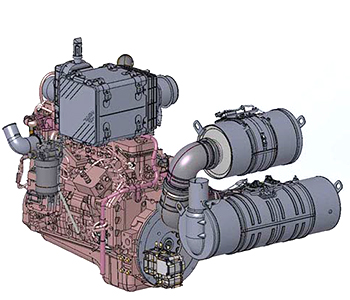 Final Tier 4 (FT4) diesel engine
Final Tier 4 (FT4) diesel engine
The Hagie D400 is powered by a 6.7-L (408.9-cu in.) Cummins QSB emissions-compliant Final Tier 4 (FT4) diesel engine rated at 145- kW (195-hp). This 6.7-L (408.9-cu in.) engine is electronic with an air-to-air cooler and turbocharger.
Engine location
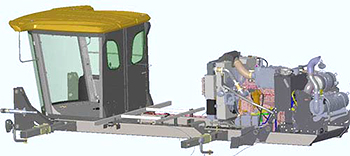 Engine location (FT4 engine shown)
Engine location (FT4 engine shown)
The rear-mounted engine keeps constant weight to offset the front attachment and leaves space in the center of machine for the varying weight of the fuel tank. This allows for better coolant airflow and reduction of cab noise.
Engine exhaust
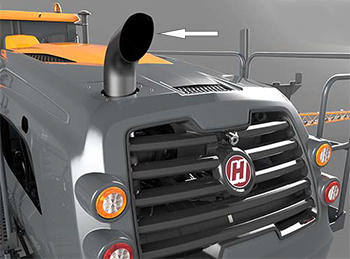 Engine exhaust stack
Engine exhaust stack
The engine exhaust is located at the rear of the machine. This helps to reduce interior cab noise and vibration.
Cummins is a trademark of Cummins, Inc. Hagie is a trademark of Hagie Manufacturing Company, LLC and similar to John Deere branded equipment, Deere will also support Hagie equipment.
D400 cab and controls overview
Overhead monitors and controls
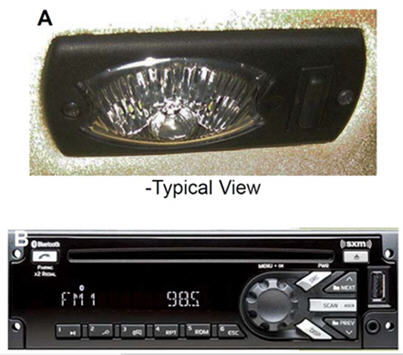



| Location (image) | Component | Description/notes |
| A | Courtesy/interior work light | The courtesy light comes on automatically when the cab door is opened. The interior work light is activated by manually pressing the interior work light switch (located on the light housing). |
| B | Stereo (if equipped) | The stereo features an AM/FM tuner, weatherband broadcasting, CD player, MP3 player, USB/ iPod® controls, and Bluetooth® wireless system (if equipped). |
| C | Climate controls | The climate controls allow the operator to set and maintain desired cab temperature. Vents are placed throughout the cab to keep air circulating and to maintain clear windows throughout the cab. |
| D | Machine display | The machine display is the central control center of the machine. It controls many of the machine’s electronically driven functions (i.e., machine drive, all-wheel steer [AWS], attachment operation, tread adjustment, detasseling systems, lights, diagnostics, etc.). |
| E | Machine gauges | The machine gauge panel on the A-post is conveniently located for viewing engine rpm, fuel level, engine coolant temperature, and engine aftertreatment level (if equipped). |
Side console
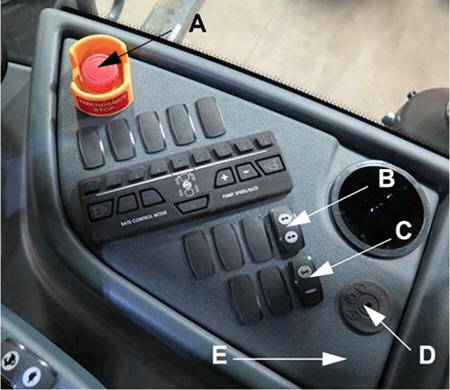
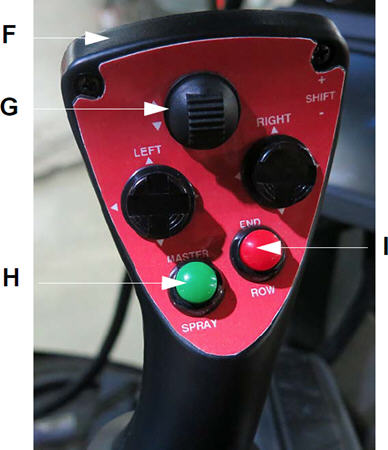
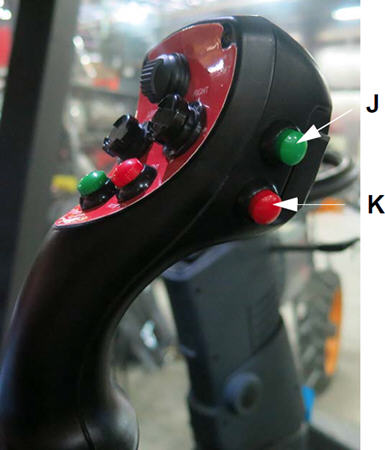
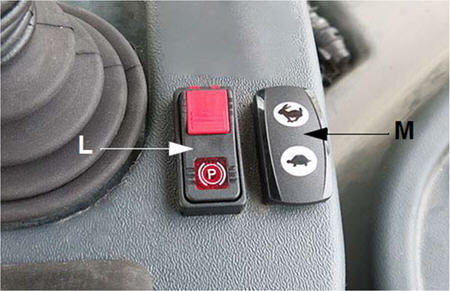
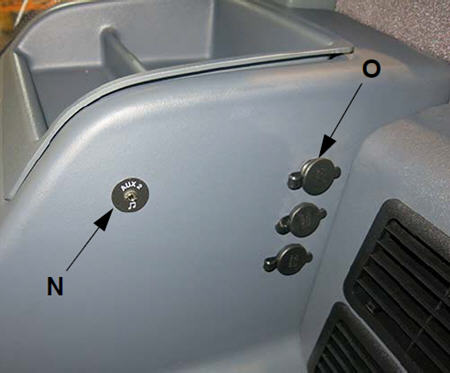
| Location (image) | Component | Description/notes |
| A | Emergency stop (e-stop) switch | The e-stop switch provides a quick method for stopping the engine in an emergency situation. |
| B | 4-1/ to 4-2 Ddetasseler toolbar slide switch (if equipped) | Provides adjustment of the toolbar from 4-1 to 4-2 row configurations if equipped |
| C | Traction valve switch | Enables the machine traction control system for 30 seconds |
| D | Ignition switch | Engages engine starter to start the machine |
| E | Power mirror switch (if equipped) | The power mirror switch allows vertical or horizontal adjustment of the electric side- view mirrors by pressing the switch in the desired position. |
| F | Hydrostatic drive control handle | The hydrostatic drive control handle controls the direction of the machine and the speed in which it travels. It is also used to control the toolbar, master control, end row management, and shift up/down speeds. |
| G | All up/down switch | All up/down switch is used to raise or lower all row units at the same time. |
| H | Main control switch | Controls the on/off state of the detasseling motors |
| I | End row management switch | The end-row management switch is a programmable switch that enables various functions (i.e., all-wheel steerAWS, auto steer, master control) when the switch is depressed. End-row management settings are programmed through the machine display. |
| J | Shift up switch | The shift up/down switches are used for speed range selection. |
| K | Shift down switch | The shift up/down switches are used for speed range selection. |
| L | Parking brake switch | The parking brake switch is used to engage and disengage the parking brake, as well as extend and retract the ladder. |
| M | Throttle switch | The throttle switch is used to control engine speed (rpm). |
| N | 12-V power ports | Four power ports are provided for the connection of additional items (such as radios and computer equipment). |
| O | Two auxiliary audio input connections | The auxiliary audio input allows connection of a personal device or MP3 player. |
Front console
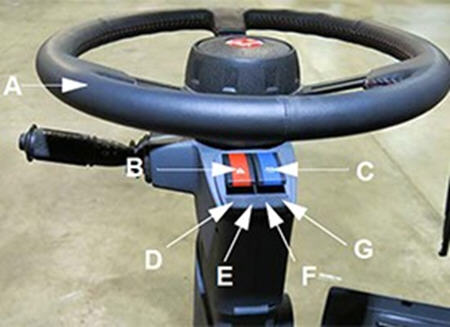
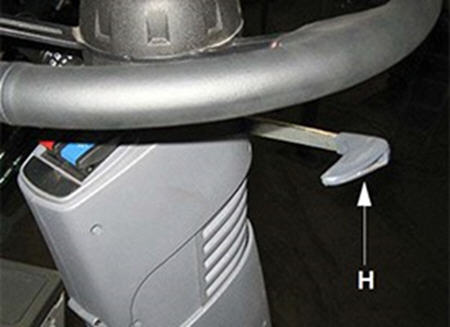
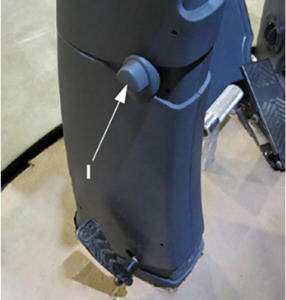

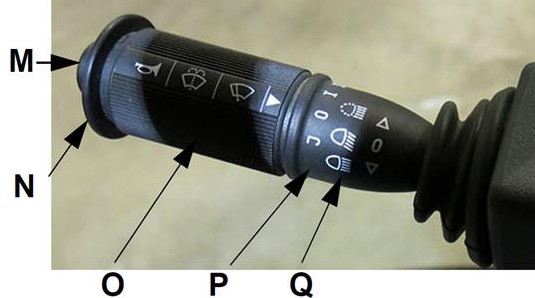
| Location (image) | Component | Description/notes |
| A | Steering wheel | Optional premium leather-wrapped steering wheel |
| B | Hazard/warning lights switch | --- |
| C | Highway running lights switch | --- |
| D | Turn signal indicator | Left-hand side |
| E | Highway running lights indicator | --- |
| F | High beams indicator | --- |
| G | Turn signal indicator | Right-hand side |
| H | Steering wheel telescope adjust handle | Available only if equipped with this option |
| I | Steering column tilt adjust button | Knee angle |
| J | Steering column release pedal | --- |
| K | Operator foot pegs | Two pegs |
| L | Deceleration (decel) pedal | --- |
| M | Horn | --- |
| N | Windshield washer | --- |
| O | Turn signal lever | --- |
| P | Windshield wiper speed | --- |
| Q | High beams (brights) | --- |
iPod is a trademark of Apple Inc. Bluetooth is a trademark of Bluetooth SIG, Inc.
Frame and axles
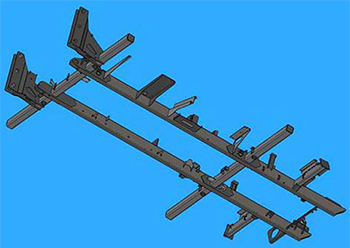 Chassis mainframe
Chassis mainframe
 Horizontal cross-through axle tube
Horizontal cross-through axle tube
The D400 Detasseler mainframe design features horizontal cross-through axle tubes, as well as toolbar and platform mounts on weldment.
- 360.7-cm (142-in.) mainframe width
- 182.9-cm (72-in.) ground clearance
Features
Agronomic benefits
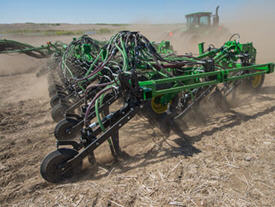
Implementing moisture conservation farming practices
Hydraulic shanks are the workhorses of the P500 Air Seeding tools. They provide consistent depth control for enhanced seed placement, resulting in more even emergence and more uniform crop maturity at harvest. The hydraulic shank seeding tool uses a rigid frame for strength and support. The openers are designed to allow independent downforce for a more uniform depth across the entire width of the frame.
Seed and fertilizer separation are not compromised when seeding with the P500. The opener design allows for banding fertilizer to 15.2 cm (6 in.) within the seedbed and up to 11.4 cm (4.5 in.) of separation between the seed and fertilizer. The deep fertilizer opener doubles as a tillage tool to shatter the hard pan for improved root development, water infiltration, and seedbed warmth.

John Deere P500 key agronomic benefits:
- Freshly exposed black soil is able to attract the sun’s radiation, warming the ground
- Warmer soil temperature promotes early germination
- Good seed to soil contact
- Necessary for germination to take place
- Seed row has been cleared of any residue or straw
- Provides a clear growth path
- Allows for abundant access to sunlight once the seedling has emerged from the ground.
- Starter nutrients placed next to seed on the shelf, promote early plant growth.
- As the plant strengthens, roots are sent off through mellow dirt into higher rate fertilizer just below the shelf
- The trench left behind helps in cupping rainfall and preventing water run off
- Provides more moisture for the plant during dry years
Depth control
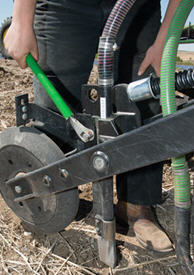 Seed depth adjustment
Seed depth adjustment

When seeding small grains and oil seeds, consistent seed and fertilizer depth control are critical for even emergence. By using two independent hydraulic accumulator force systems, the John Deere opener allows the seed and fertilizer opener trip forces to be set independent of each other.
The use of independent hydraulic accumulator technology, combined with the separate packer wheel force, allows seed-depth gauging to be done on each individual row by the press wheel.
The breakout force for the fertilizer shank is set by adjusting the large accumulator pressure. The press wheel and seed opener down force are set by adjusting pressure on the smaller accumulator. Trip force for the seed opener is set by adjusting a spring shock attached to the seed opener.
 Hydraulic controls to adjust trip force and packing pressure on 12.2-m (40-ft) and 17-m (56-ft) models - the 23.2-m (76-ft) P576 will have TruSet™ technology for depth control
Hydraulic controls to adjust trip force and packing pressure on 12.2-m (40-ft) and 17-m (56-ft) models - the 23.2-m (76-ft) P576 will have TruSet™ technology for depth control
Seeding with the P500 gives uncompromised control for seeding operation. Producers are able to maintain safe seed and fertilizer separation with depth placement up to 15.2 cm (6 in.) for the fertilizer.
Setting the fertilizer and seed depth is a very simple process. Fertilizer depth across the machine is set by the frame. Adjusting the seed tube up or down on each individual row-unit sets the preferred seed depth. The tube is positively locked tight by the freshly designed cam system.
Rear cart duals are recommended to help reduce deflection on the front hitch of the tool with a tow-between cart. Adding air pressure, without exceeding maximum psi, will also assist with reducing deflection.
For the 23.2-m (76-ft) P576 TruSet technology will control depth and pressure. Read more about TruSet here.
Fertilizer placement

Whether using dry, liquid, or anhydrous ammonia, the John Deere P500 opener has the options that fit the application needs.
|
|
|
|
|
|
|
AA74478 Aqua anhydrous point |
AA69276 NH3 point |
AA74476 Liquid fertilizer point |
AA69277 Dry fertilizer point |
AA86117 Mud special point |
Description |
Austempered 10B38 boron steel point with hardfaced areas and induction fused carbide inserts to prevent wear. Carbide plates are 4-mm (0.16-in.) thick along the point edge and 6-mm (0.24-in.) thick on the tip. |
||||
Application |
Aqua anhydrous |
Anhydrous |
Liquid fertilizer |
Dry fertilizer** |
Dry fertilizer |
Option code |
1255 |
1250 |
1215/1220 |
--- |
1235 |
Tube diameter (OD) |
9.5 mm (3/8 in.) |
12.7 mm (1/2 in.) |
6.35 mm (1/4 in.) |
--- |
--- |
Pin on |
X |
X |
X |
X |
X |
High top |
X |
X |
X |
X |
X |
Suitable for dry conditions |
X |
X |
X |
X |
X |
Suitable for muddy conditions |
X* |
X* |
X* |
--- |
X |
Dry fertilizer tube add-on |
AA69271 |
AA69271 |
AA69271 |
AA69266 |
--- |
Weight |
0.9 kg (2 lb) |
0.97 kg (2.14 lb) |
0.88 kg (1.95 lb) |
0.86 kg (1.9 lb) |
1.7 kg (3.78 lb) |
Other information |
This form of ammonia is produced by dissolving ammonia gas in water.
AA69272 hose guide is required if dry fertilizer tube is not installed. |
Anhydrous ammonia is compressed into a clear, colorless liquid.
AA69272 hose guide is required if dry fertilizer tube is not installed. |
AA69272 hose guide is required if dry fertilizer tube is not installed. |
--- |
Replaces AA69279.
Wear-resistant hardfaced welds increased by 75 percent.
Thickness increase from 4 to 8 mm (0.16 to 0.3 in.).
Extra 12.7-mm (1/2-in.) weld added close to heavy wear area. |
*If not using dry fertilizer tube add-on **Dry tube required |
|||||
 Anhydrous high top tip (left) versus aqua anhydrous tip (right)
Anhydrous high top tip (left) versus aqua anhydrous tip (right)
This picture shows the difference between the anhydrous high top and aqua anhydrous tips pictured in the chart above. On the left, the anhydrous high top has a thicker tube wall (1.3-cm [0.5-in.] outer diameter) than the aqua anhydrous tip, though the inner diameter of both tips are equal. The NH3 knives may also be used in combination with the included dry-delivery tube for those wanting to apply NH3 and dry fertilizers simultaneously in the same fertilizer trench.
Additional information for code 1235: the mud-proof combination of dry-fertilizer tube and tip, code 1235, is available for those applying dry fertilizers only. This is recommended for running in sticky, heavy clay-type soils. However, it works well in all soil types to prevent mud from plugging the fertilizer tube opening. This opener is included as base equipment.
If seeding with dry fertilizer only, this option is highly recommended. The fertilizer exits the tube at a lower point, allowing growers desiring to place fertilizer at shallower depths more consistently.
The lower fertilizer exit point also allows the fertilizer to get to the bottom of the trench when more fertilizer and seed separation is desired, and for those light soils that tend to cave in the trench before the fertilizer is placed.
 P500 fertilizer shanks engaged in the ground
P500 fertilizer shanks engaged in the ground
| Fertilizer tubes | |
| 1.) AA69266 (1250) - Dry fertilizer |  |
| 2.) AA69271 (1220/50/55) - Dry fertilizer with NH3 or liquid |  |
| 3.) AA69272 (1215) - Liquid tube |  |
TruSet™ depth and pressure control for 23.2-m (76-ft) P576
 TruSet screen on GreenStar™ 3 2630 Display
TruSet screen on GreenStar™ 3 2630 Display
Exclusive TruSet depth and pressure control has taken adjustability on the 23.2-m (76-ft) P576 to a whole new level. Rather than using manual valve handles, pressure control dials on the monitor let operators make incremental adjustments to trip force and packing pressure conveniently from inside the tractor cab. This also saves time and makes it easier to adapt to changing field conditions.
Controls on the GreenStar 3 2630 Display also allow operators to predetermine a targeted seeding and fertilizer depth. Changes to target maximum and minimum working depth can be made easily on the same run screen. A flick adjustment feature will move openers up or down in short increments if desired. There is no longer a need to get out of the cab to add or remove shims and spacers for depth changes. Plus, TruSet makes side-to-side frame leveling easier. It adjusts at the press of a button on the GreenStar 3 2630 Display.
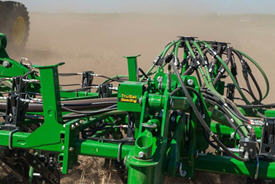

There is a rotary position sensor under the TruSet plate. In the lower right-hand corner is the valve that regulates the flow of oil to and from the cylinder. There is a sensor associated with each wheel module – or six per machine.
Competitive tractors require an add-on selective control valve (SCV) kit for TruSet to function properly.
RelativeFlow™ Blockage sensing
 RelativeFlow blockage sensing
RelativeFlow blockage sensing
With the RelativeFlow blockage system, operators can see the flow rate of both seed and fertilizer from inside the tractor cab. Sensors on delivery hoses monitor the relative rate of product flow. An easy-to-read display clearly visualizes relative product flow across the drill, from opener to opener. This exclusive technology gives a better view of what is happening across the tool in order to spot problems before blockage occurs.
RelativeFlow Blockage is available on the following models:
- P540 - 12.2-m (40-ft)
- P556 - 17.1-m (56-ft)
- P576 - 23.2-m (76-ft)
- N500C - all widths
- 1890 - 15.2-m (50-ft) and 18.3-m (60-ft)
- N530F - 9.1-m (30-ft)
- N540F - 12.2-m (40-ft)
- N543F - 13.1-m (43-ft)
- N560F - 18.3-m (60-ft)
Below are the GreenStar™ 3 2630 Display screens for the blockage monitoring system. For complete details and information, see the owner’s manual.
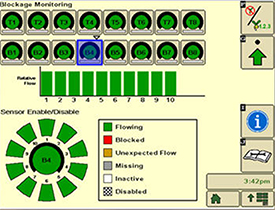 Blockage monitoring screen
Blockage monitoring screen
The RelativeFlow system chart shows the amount of flow through each sensor on the selected tower. Sensitivity for the blockage system can be adjusted if desired, as shown below.
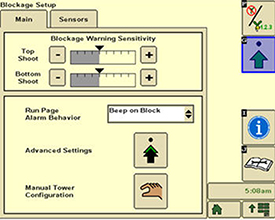 Blockage set-up screen
Blockage set-up screen
Blockage warning sensitivity allows the producer to set and change the sensitivity of the sensors to meet their preferences. Increasing the sensitivity means the system is more likely to show a false blockage, while less sensitivity means the system is more likely to miss a blockage.
Multiple run-page alarm behavior options are available for selection.
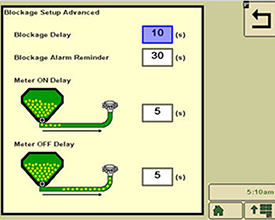 Blockage set-up screen
Blockage set-up screen
Below are the Gen 4 display screens for the blockage monitoring system on the N500C.
For complete details and information reference, the owner’s manual.
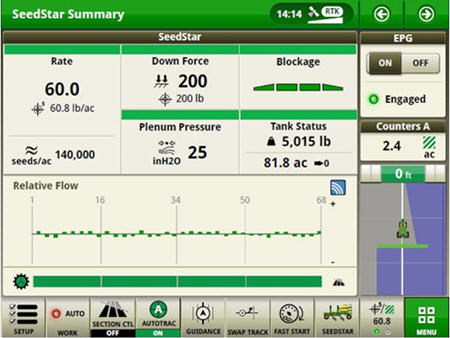 RelativeFlow Blockage configured run page
RelativeFlow Blockage configured run page
The SeedStar™ system run page displays the five major run settings. Clicking on any of the tiles will take an operator to that specific page (shown below).
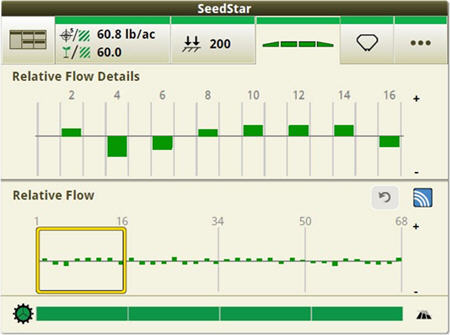 Operators can zoom into flow details by meter section when selecting Blockage tiles
Operators can zoom into flow details by meter section when selecting Blockage tiles
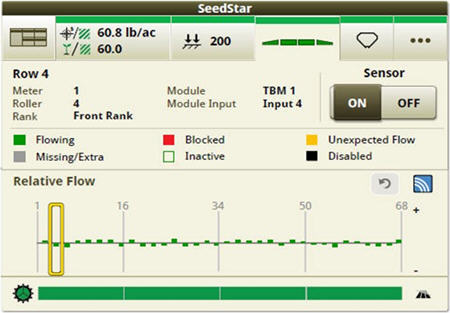 Operators can zoom into the row level to access row/sensor information and turn a sensor on/off independently
Operators can zoom into the row level to access row/sensor information and turn a sensor on/off independently
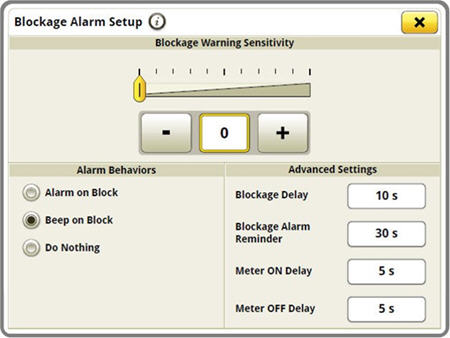 Blockage sensitivities and alarm delays are all set up on one easy-to-navigate screen
Blockage sensitivities and alarm delays are all set up on one easy-to-navigate screen
Blockage alarm delays can be set up by clicking on the advanced settings button from the blockage set-up screen.
- A blockage delay is how long a blockage should occur before an alarm is sounded.
- The blockage alarm reminder is how often the alarm should sound when a blockage occurs.
- The meter on delay is the time from when the meter is turned on until the blockage sensor should start monitoring for blockage.
- The meter off delay is the time from when the meter is turned off until the blockage sensor should start monitoring to verify no flow.
For more detailed information, see the owner’s manual.
Air tools with Relative Flow Blockage are not compatible with 1910 air carts with ground drive.
Row spacing options
Paired row vs. side banded
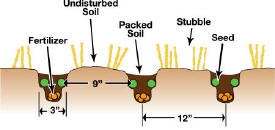 Paired row soil profile
Paired row soil profile

The P500 has two cast seed boots available. Depending on a grower’s seed and fertilizer placement preference in different soils or different crops, the P500 can meet the user’s needs. The cast opener was designed with simplicity in mind. One tube is all that is necessary. Switching from single to paired row has never been easier; simply remove the two bolts holding the cast opener in place, remove the opener, and replace with the new opener.
Paired row
With shanks on 30.5-cm (12-in.) spacing, paired rows can be planted with 22.9-cm (9-in.) spacing. Seed is banded in two rows above and to the sides of the furrow. Total tillage in this zone is 7.6-cm (3-in.) wide with about 25 percent seedbed utilization (SBU).
Seed is laid on a 2-cm (0.75-in.) shelf while fertilizer is placed in a 2.5-cm (1-in.) band between and below the two seed rows.
With paired row placement, the crop is able to access the fertilizer when it needs it. The separation is enough to safely keep the seed from burning. The P500 provides a well-prepared seedbed for quick emergence and quicker canopy, which will help eliminate weeds. If the operator is looking to swath wider rows, support the heavy green crop.
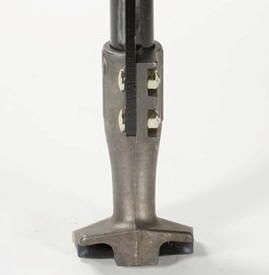 Paired row opener - rear shot
Paired row opener - rear shot
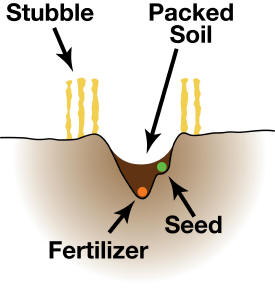 Single row/side banded soil profile
Single row/side banded soil profile

Side banded
If the seeding operation calls for side banding, the P500 is the needed tool. The side-banding seed tube places the seed on a firm bed of soil above and to the side of fertilizer as required. There are 30.5-cm (12-in.) rows across the machine with positive separation between seed and fertilizer up to 11.4 cm (4.5 in.). As the seed germinates and begins to emerge, its roots will be 7.6-cm to 10.2-cm (3-in. to 4-in.) deep and into the nutrient zone.
John Deere recognizes not all seeding conditions are identical and, with the P500, offers solutions to meet seed and fertilizer placement needs.
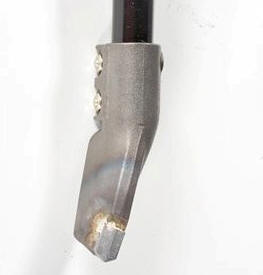 Single row/side banded
Single row/side banded
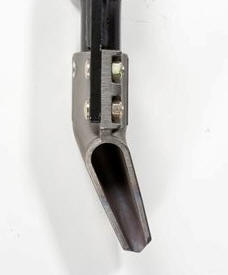 Single row/side banded - rear shot
Single row/side banded - rear shot
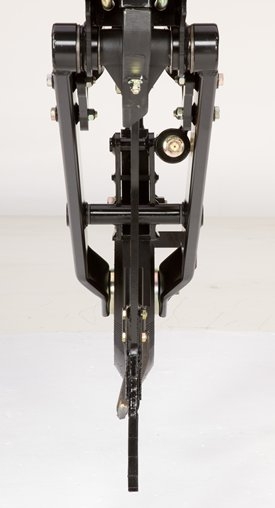 Single row seed boot in-line
Single row seed boot in-line
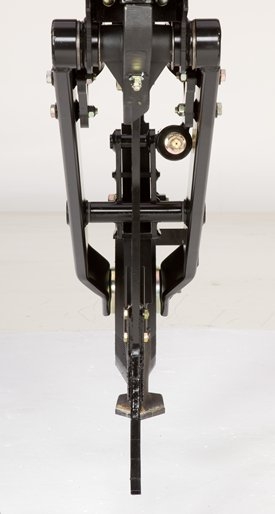 Paired row seed boot in-line
Paired row seed boot in-line
High-flotation kit for 23.2-m (76-ft) P576 Precision Hoe Drill
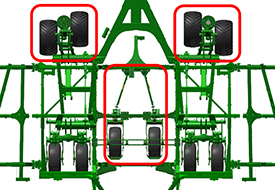 High-flotation package for P576
High-flotation package for P576
 Large front mainframe tires
Large front mainframe tires
For small-grain producers who want to increase flotation and reduce compaction, a high-flotation kit is available for the 23.2-m (76-ft) P576 Precision Hoe Drill.
Customer value
The high-flotation kit for the 23.2-m (76-ft) P576 Precision Hoe Drill provides producers with excellent performance, a boost in uptime, and reduced cost of operation. The high-flotation package consists of two main components: larger front mainframe tires and an in-frame lift assist system. This complete package results in:
- 91.7 percent increase in flat plate area for front wheels
- 60 percent improvement in stuck factor for wheels
- Reduction in tire inflation pressures
- Reduction in ground pressures
- Ability to get in the field sooner if desired
How it works
The high-flotation kit works in two ways:
- The larger front mainframe tires add an increase in flotation to the front of the machine.
- The in-frame lift assist system utilizes the power beyond circuit and a hydraulic valve block to set system pressure, utilizing accumulators to raise and lower the system. The in-frame system has new components to be installed within the existing mainframe to increase flotation and allow the machine weight to be spread across additional tire surface area.
High-flotation kit components
Larger front mainframe tires:
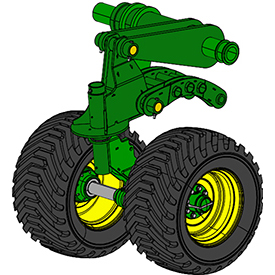 Front mainframe tires
Front mainframe tires
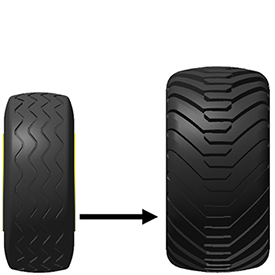 91.7 percent increase in flat plate area
91.7 percent increase in flat plate area
| Standard front tires | High-flotation front tires | |
| Tire | 440/55R18 | 550/45-22.5 |
| Load capacity | 4377.2 kg (9650 lb) | 3646.9 kg (8040 lb) |
| Inflation pressure | 5 bar (73 psi) | 1.5 bar (22 psi) |
| Outside diameter | 94.2 cm (37.1 in.) | 106.9 cm (42.1 in.) |
| Width | 43.4 cm (17.1 in.) | 55.1 cm (21.7 in.) |
| Static loaded radius | 42.2 cm (16.6 in.) | 47 cm (18.5 in.) |
| Flat plate area | 1006.5 cm2 (156 sq in.) | 1929 cm2 (299 sq in.) |
Lift assist system:
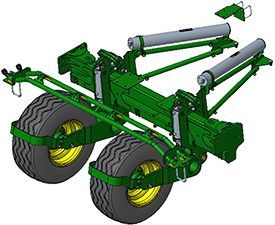
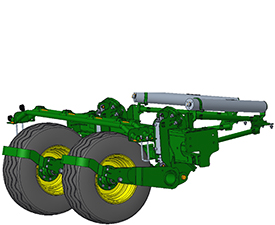
This kit does not include any 440/55R18 tires for the lift assist system. The producer will use the 440/55R18 tires from the mainframe front that will be replaced by 550/45-22.5 tires as part of the kit pre-delivery inspection (PDI) process.
Compatibility
This kit is compatible with all 23.2-m (76-ft) P576 Precision Hoe Drills.
Ordering
This kit will be initially offered as a product enhancement program (PEP). See PEP #18AX461 for more details.
| Attachment | Description |
| MPA10950 | 23.2-m (76-ft) P576 High-flotation PEP kit NOTE: Includes larger front tires and assembly and lift assist system. Does not include 440/55R18 tires. |
Mainframe and wing wheel scrapers

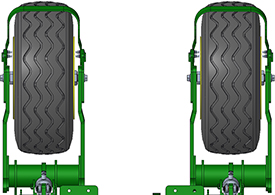
The mainframe and wing wheel scrapers have been redesigned to better meet producer needs. These scrapers are included in the high-flotation kit. BA33708 can also be ordered separately if the grower does not want the flotation kit.
| Attachment | Description |
| BA33708 | Main frame and wing wheel scrapers NOTE: Order one kit per 23.2-m (76-ft) P576 Drill. |
Features
Agronomic benefits

Implementing moisture conservation farming practices
Hydraulic shanks are the workhorses of the P500 Air Seeding tools. They provide consistent depth control for enhanced seed placement, resulting in more even emergence and more uniform crop maturity at harvest. The hydraulic shank seeding tool uses a rigid frame for strength and support. The openers are designed to allow independent downforce for a more uniform depth across the entire width of the frame.
Seed and fertilizer separation are not compromised when seeding with the P500. The opener design allows for banding fertilizer to 15.2 cm (6 in.) within the seedbed and up to 11.4 cm (4.5 in.) of separation between the seed and fertilizer. The deep fertilizer opener doubles as a tillage tool to shatter the hard pan for improved root development, water infiltration, and seedbed warmth.

John Deere P500 key agronomic benefits:
- Freshly exposed black soil is able to attract the sun’s radiation, warming the ground
- Warmer soil temperature promotes early germination
- Good seed to soil contact
- Necessary for germination to take place
- Seed row has been cleared of any residue or straw
- Provides a clear growth path
- Allows for abundant access to sunlight once the seedling has emerged from the ground.
- Starter nutrients placed next to seed on the shelf, promote early plant growth.
- As the plant strengthens, roots are sent off through mellow dirt into higher rate fertilizer just below the shelf
- The trench left behind helps in cupping rainfall and preventing water run off
- Provides more moisture for the plant during dry years
Depth control
 Seed depth adjustment
Seed depth adjustment

When seeding small grains and oil seeds, consistent seed and fertilizer depth control are critical for even emergence. By using two independent hydraulic accumulator force systems, the John Deere opener allows the seed and fertilizer opener trip forces to be set independent of each other.
The use of independent hydraulic accumulator technology, combined with the separate packer wheel force, allows seed-depth gauging to be done on each individual row by the press wheel.
The breakout force for the fertilizer shank is set by adjusting the large accumulator pressure. The press wheel and seed opener down force are set by adjusting pressure on the smaller accumulator. Trip force for the seed opener is set by adjusting a spring shock attached to the seed opener.
 Hydraulic controls to adjust trip force and packing pressure on 12.2-m (40-ft) and 17-m (56-ft) models - the 23.2-m (76-ft) P576 will have TruSet™ technology for depth control
Hydraulic controls to adjust trip force and packing pressure on 12.2-m (40-ft) and 17-m (56-ft) models - the 23.2-m (76-ft) P576 will have TruSet™ technology for depth control
Seeding with the P500 gives uncompromised control for seeding operation. Producers are able to maintain safe seed and fertilizer separation with depth placement up to 15.2 cm (6 in.) for the fertilizer.
Setting the fertilizer and seed depth is a very simple process. Fertilizer depth across the machine is set by the frame. Adjusting the seed tube up or down on each individual row-unit sets the preferred seed depth. The tube is positively locked tight by the freshly designed cam system.
Rear cart duals are recommended to help reduce deflection on the front hitch of the tool with a tow-between cart. Adding air pressure, without exceeding maximum psi, will also assist with reducing deflection.
For the 23.2-m (76-ft) P576 TruSet technology will control depth and pressure. Read more about TruSet here.
Fertilizer placement

Whether using dry, liquid, or anhydrous ammonia, the John Deere P500 opener has the options that fit the application needs.
|
|
|
|
|
|
|
AA74478 Aqua anhydrous point |
AA69276 NH3 point |
AA74476 Liquid fertilizer point |
AA69277 Dry fertilizer point |
AA86117 Mud special point |
Description |
Austempered 10B38 boron steel point with hardfaced areas and induction fused carbide inserts to prevent wear. Carbide plates are 4-mm (0.16-in.) thick along the point edge and 6-mm (0.24-in.) thick on the tip. |
||||
Application |
Aqua anhydrous |
Anhydrous |
Liquid fertilizer |
Dry fertilizer** |
Dry fertilizer |
Option code |
1255 |
1250 |
1215/1220 |
--- |
1235 |
Tube diameter (OD) |
9.5 mm (3/8 in.) |
12.7 mm (1/2 in.) |
6.35 mm (1/4 in.) |
--- |
--- |
Pin on |
X |
X |
X |
X |
X |
High top |
X |
X |
X |
X |
X |
Suitable for dry conditions |
X |
X |
X |
X |
X |
Suitable for muddy conditions |
X* |
X* |
X* |
--- |
X |
Dry fertilizer tube add-on |
AA69271 |
AA69271 |
AA69271 |
AA69266 |
--- |
Weight |
0.9 kg (2 lb) |
0.97 kg (2.14 lb) |
0.88 kg (1.95 lb) |
0.86 kg (1.9 lb) |
1.7 kg (3.78 lb) |
Other information |
This form of ammonia is produced by dissolving ammonia gas in water.
AA69272 hose guide is required if dry fertilizer tube is not installed. |
Anhydrous ammonia is compressed into a clear, colorless liquid.
AA69272 hose guide is required if dry fertilizer tube is not installed. |
AA69272 hose guide is required if dry fertilizer tube is not installed. |
--- |
Replaces AA69279.
Wear-resistant hardfaced welds increased by 75 percent.
Thickness increase from 4 to 8 mm (0.16 to 0.3 in.).
Extra 12.7-mm (1/2-in.) weld added close to heavy wear area. |
*If not using dry fertilizer tube add-on **Dry tube required |
|||||
 Anhydrous high top tip (left) versus aqua anhydrous tip (right)
Anhydrous high top tip (left) versus aqua anhydrous tip (right)
This picture shows the difference between the anhydrous high top and aqua anhydrous tips pictured in the chart above. On the left, the anhydrous high top has a thicker tube wall (1.3-cm [0.5-in.] outer diameter) than the aqua anhydrous tip, though the inner diameter of both tips are equal. The NH3 knives may also be used in combination with the included dry-delivery tube for those wanting to apply NH3 and dry fertilizers simultaneously in the same fertilizer trench.
Additional information for code 1235: the mud-proof combination of dry-fertilizer tube and tip, code 1235, is available for those applying dry fertilizers only. This is recommended for running in sticky, heavy clay-type soils. However, it works well in all soil types to prevent mud from plugging the fertilizer tube opening. This opener is included as base equipment.
If seeding with dry fertilizer only, this option is highly recommended. The fertilizer exits the tube at a lower point, allowing growers desiring to place fertilizer at shallower depths more consistently.
The lower fertilizer exit point also allows the fertilizer to get to the bottom of the trench when more fertilizer and seed separation is desired, and for those light soils that tend to cave in the trench before the fertilizer is placed.
 P500 fertilizer shanks engaged in the ground
P500 fertilizer shanks engaged in the ground
| Fertilizer tubes | |
| 1.) AA69266 (1250) - Dry fertilizer |  |
| 2.) AA69271 (1220/50/55) - Dry fertilizer with NH3 or liquid |  |
| 3.) AA69272 (1215) - Liquid tube |  |
RelativeFlow™ Blockage sensing
 RelativeFlow blockage sensing
RelativeFlow blockage sensing
With the RelativeFlow blockage system, operators can see the flow rate of both seed and fertilizer from inside the tractor cab. Sensors on delivery hoses monitor the relative rate of product flow. An easy-to-read display clearly visualizes relative product flow across the drill, from opener to opener. This exclusive technology gives a better view of what is happening across the tool in order to spot problems before blockage occurs.
RelativeFlow Blockage is available on the following models:
- P540 - 12.2-m (40-ft)
- P556 - 17.1-m (56-ft)
- P576 - 23.2-m (76-ft)
- N500C - all widths
- 1890 - 15.2-m (50-ft) and 18.3-m (60-ft)
- N530F - 9.1-m (30-ft)
- N540F - 12.2-m (40-ft)
- N543F - 13.1-m (43-ft)
- N560F - 18.3-m (60-ft)
Below are the GreenStar™ 3 2630 Display screens for the blockage monitoring system. For complete details and information, see the owner’s manual.
 Blockage monitoring screen
Blockage monitoring screen
The RelativeFlow system chart shows the amount of flow through each sensor on the selected tower. Sensitivity for the blockage system can be adjusted if desired, as shown below.
 Blockage set-up screen
Blockage set-up screen
Blockage warning sensitivity allows the producer to set and change the sensitivity of the sensors to meet their preferences. Increasing the sensitivity means the system is more likely to show a false blockage, while less sensitivity means the system is more likely to miss a blockage.
Multiple run-page alarm behavior options are available for selection.
 Blockage set-up screen
Blockage set-up screen
Below are the Gen 4 display screens for the blockage monitoring system on the N500C.
For complete details and information reference, the owner’s manual.
 RelativeFlow Blockage configured run page
RelativeFlow Blockage configured run page
The SeedStar™ system run page displays the five major run settings. Clicking on any of the tiles will take an operator to that specific page (shown below).
 Operators can zoom into flow details by meter section when selecting Blockage tiles
Operators can zoom into flow details by meter section when selecting Blockage tiles
 Operators can zoom into the row level to access row/sensor information and turn a sensor on/off independently
Operators can zoom into the row level to access row/sensor information and turn a sensor on/off independently
 Blockage sensitivities and alarm delays are all set up on one easy-to-navigate screen
Blockage sensitivities and alarm delays are all set up on one easy-to-navigate screen
Blockage alarm delays can be set up by clicking on the advanced settings button from the blockage set-up screen.
- A blockage delay is how long a blockage should occur before an alarm is sounded.
- The blockage alarm reminder is how often the alarm should sound when a blockage occurs.
- The meter on delay is the time from when the meter is turned on until the blockage sensor should start monitoring for blockage.
- The meter off delay is the time from when the meter is turned off until the blockage sensor should start monitoring to verify no flow.
For more detailed information, see the owner’s manual.
Air tools with Relative Flow Blockage are not compatible with 1910 air carts with ground drive.
Row spacing options
Paired row vs. side banded
 Paired row soil profile
Paired row soil profile

The P500 has two cast seed boots available. Depending on a grower’s seed and fertilizer placement preference in different soils or different crops, the P500 can meet the user’s needs. The cast opener was designed with simplicity in mind. One tube is all that is necessary. Switching from single to paired row has never been easier; simply remove the two bolts holding the cast opener in place, remove the opener, and replace with the new opener.
Paired row
With shanks on 30.5-cm (12-in.) spacing, paired rows can be planted with 22.9-cm (9-in.) spacing. Seed is banded in two rows above and to the sides of the furrow. Total tillage in this zone is 7.6-cm (3-in.) wide with about 25 percent seedbed utilization (SBU).
Seed is laid on a 2-cm (0.75-in.) shelf while fertilizer is placed in a 2.5-cm (1-in.) band between and below the two seed rows.
With paired row placement, the crop is able to access the fertilizer when it needs it. The separation is enough to safely keep the seed from burning. The P500 provides a well-prepared seedbed for quick emergence and quicker canopy, which will help eliminate weeds. If the operator is looking to swath wider rows, support the heavy green crop.
 Paired row opener - rear shot
Paired row opener - rear shot
 Single row/side banded soil profile
Single row/side banded soil profile

Side banded
If the seeding operation calls for side banding, the P500 is the needed tool. The side-banding seed tube places the seed on a firm bed of soil above and to the side of fertilizer as required. There are 30.5-cm (12-in.) rows across the machine with positive separation between seed and fertilizer up to 11.4 cm (4.5 in.). As the seed germinates and begins to emerge, its roots will be 7.6-cm to 10.2-cm (3-in. to 4-in.) deep and into the nutrient zone.
John Deere recognizes not all seeding conditions are identical and, with the P500, offers solutions to meet seed and fertilizer placement needs.
 Single row/side banded
Single row/side banded
 Single row/side banded - rear shot
Single row/side banded - rear shot
 Single row seed boot in-line
Single row seed boot in-line
 Paired row seed boot in-line
Paired row seed boot in-line
Features
Agronomic benefits

Implementing moisture conservation farming practices
Hydraulic shanks are the workhorses of the P500 Air Seeding tools. They provide consistent depth control for enhanced seed placement, resulting in more even emergence and more uniform crop maturity at harvest. The hydraulic shank seeding tool uses a rigid frame for strength and support. The openers are designed to allow independent downforce for a more uniform depth across the entire width of the frame.
Seed and fertilizer separation are not compromised when seeding with the P500. The opener design allows for banding fertilizer to 15.2 cm (6 in.) within the seedbed and up to 11.4 cm (4.5 in.) of separation between the seed and fertilizer. The deep fertilizer opener doubles as a tillage tool to shatter the hard pan for improved root development, water infiltration, and seedbed warmth.

John Deere P500 key agronomic benefits:
- Freshly exposed black soil is able to attract the sun’s radiation, warming the ground
- Warmer soil temperature promotes early germination
- Good seed to soil contact
- Necessary for germination to take place
- Seed row has been cleared of any residue or straw
- Provides a clear growth path
- Allows for abundant access to sunlight once the seedling has emerged from the ground.
- Starter nutrients placed next to seed on the shelf, promote early plant growth.
- As the plant strengthens, roots are sent off through mellow dirt into higher rate fertilizer just below the shelf
- The trench left behind helps in cupping rainfall and preventing water run off
- Provides more moisture for the plant during dry years
Depth control
 Seed depth adjustment
Seed depth adjustment

When seeding small grains and oil seeds, consistent seed and fertilizer depth control are critical for even emergence. By using two independent hydraulic accumulator force systems, the John Deere opener allows the seed and fertilizer opener trip forces to be set independent of each other.
The use of independent hydraulic accumulator technology, combined with the separate packer wheel force, allows seed-depth gauging to be done on each individual row by the press wheel.
The breakout force for the fertilizer shank is set by adjusting the large accumulator pressure. The press wheel and seed opener down force are set by adjusting pressure on the smaller accumulator. Trip force for the seed opener is set by adjusting a spring shock attached to the seed opener.
 Hydraulic controls to adjust trip force and packing pressure on 12.2-m (40-ft) and 17-m (56-ft) models - the 23.2-m (76-ft) P576 will have TruSet™ technology for depth control
Hydraulic controls to adjust trip force and packing pressure on 12.2-m (40-ft) and 17-m (56-ft) models - the 23.2-m (76-ft) P576 will have TruSet™ technology for depth control
Seeding with the P500 gives uncompromised control for seeding operation. Producers are able to maintain safe seed and fertilizer separation with depth placement up to 15.2 cm (6 in.) for the fertilizer.
Setting the fertilizer and seed depth is a very simple process. Fertilizer depth across the machine is set by the frame. Adjusting the seed tube up or down on each individual row-unit sets the preferred seed depth. The tube is positively locked tight by the freshly designed cam system.
Rear cart duals are recommended to help reduce deflection on the front hitch of the tool with a tow-between cart. Adding air pressure, without exceeding maximum psi, will also assist with reducing deflection.
For the 23.2-m (76-ft) P576 TruSet technology will control depth and pressure. Read more about TruSet here.
Fertilizer placement

Whether using dry, liquid, or anhydrous ammonia, the John Deere P500 opener has the options that fit the application needs.
|
|
|
|
|
|
|
AA74478 Aqua anhydrous point |
AA69276 NH3 point |
AA74476 Liquid fertilizer point |
AA69277 Dry fertilizer point |
AA86117 Mud special point |
Description |
Austempered 10B38 boron steel point with hardfaced areas and induction fused carbide inserts to prevent wear. Carbide plates are 4-mm (0.16-in.) thick along the point edge and 6-mm (0.24-in.) thick on the tip. |
||||
Application |
Aqua anhydrous |
Anhydrous |
Liquid fertilizer |
Dry fertilizer** |
Dry fertilizer |
Option code |
1255 |
1250 |
1215/1220 |
--- |
1235 |
Tube diameter (OD) |
9.5 mm (3/8 in.) |
12.7 mm (1/2 in.) |
6.35 mm (1/4 in.) |
--- |
--- |
Pin on |
X |
X |
X |
X |
X |
High top |
X |
X |
X |
X |
X |
Suitable for dry conditions |
X |
X |
X |
X |
X |
Suitable for muddy conditions |
X* |
X* |
X* |
--- |
X |
Dry fertilizer tube add-on |
AA69271 |
AA69271 |
AA69271 |
AA69266 |
--- |
Weight |
0.9 kg (2 lb) |
0.97 kg (2.14 lb) |
0.88 kg (1.95 lb) |
0.86 kg (1.9 lb) |
1.7 kg (3.78 lb) |
Other information |
This form of ammonia is produced by dissolving ammonia gas in water.
AA69272 hose guide is required if dry fertilizer tube is not installed. |
Anhydrous ammonia is compressed into a clear, colorless liquid.
AA69272 hose guide is required if dry fertilizer tube is not installed. |
AA69272 hose guide is required if dry fertilizer tube is not installed. |
--- |
Replaces AA69279.
Wear-resistant hardfaced welds increased by 75 percent.
Thickness increase from 4 to 8 mm (0.16 to 0.3 in.).
Extra 12.7-mm (1/2-in.) weld added close to heavy wear area. |
*If not using dry fertilizer tube add-on **Dry tube required |
|||||
 Anhydrous high top tip (left) versus aqua anhydrous tip (right)
Anhydrous high top tip (left) versus aqua anhydrous tip (right)
This picture shows the difference between the anhydrous high top and aqua anhydrous tips pictured in the chart above. On the left, the anhydrous high top has a thicker tube wall (1.3-cm [0.5-in.] outer diameter) than the aqua anhydrous tip, though the inner diameter of both tips are equal. The NH3 knives may also be used in combination with the included dry-delivery tube for those wanting to apply NH3 and dry fertilizers simultaneously in the same fertilizer trench.
Additional information for code 1235: the mud-proof combination of dry-fertilizer tube and tip, code 1235, is available for those applying dry fertilizers only. This is recommended for running in sticky, heavy clay-type soils. However, it works well in all soil types to prevent mud from plugging the fertilizer tube opening. This opener is included as base equipment.
If seeding with dry fertilizer only, this option is highly recommended. The fertilizer exits the tube at a lower point, allowing growers desiring to place fertilizer at shallower depths more consistently.
The lower fertilizer exit point also allows the fertilizer to get to the bottom of the trench when more fertilizer and seed separation is desired, and for those light soils that tend to cave in the trench before the fertilizer is placed.
 P500 fertilizer shanks engaged in the ground
P500 fertilizer shanks engaged in the ground
| Fertilizer tubes | |
| 1.) AA69266 (1250) - Dry fertilizer |  |
| 2.) AA69271 (1220/50/55) - Dry fertilizer with NH3 or liquid |  |
| 3.) AA69272 (1215) - Liquid tube |  |
RelativeFlow™ Blockage sensing
 RelativeFlow blockage sensing
RelativeFlow blockage sensing
With the RelativeFlow blockage system, operators can see the flow rate of both seed and fertilizer from inside the tractor cab. Sensors on delivery hoses monitor the relative rate of product flow. An easy-to-read display clearly visualizes relative product flow across the drill, from opener to opener. This exclusive technology gives a better view of what is happening across the tool in order to spot problems before blockage occurs.
RelativeFlow Blockage is available on the following models:
- P540 - 12.2-m (40-ft)
- P556 - 17.1-m (56-ft)
- P576 - 23.2-m (76-ft)
- N500C - all widths
- 1890 - 15.2-m (50-ft) and 18.3-m (60-ft)
- N530F - 9.1-m (30-ft)
- N540F - 12.2-m (40-ft)
- N543F - 13.1-m (43-ft)
- N560F - 18.3-m (60-ft)
Below are the GreenStar™ 3 2630 Display screens for the blockage monitoring system. For complete details and information, see the owner’s manual.
 Blockage monitoring screen
Blockage monitoring screen
The RelativeFlow system chart shows the amount of flow through each sensor on the selected tower. Sensitivity for the blockage system can be adjusted if desired, as shown below.
 Blockage set-up screen
Blockage set-up screen
Blockage warning sensitivity allows the producer to set and change the sensitivity of the sensors to meet their preferences. Increasing the sensitivity means the system is more likely to show a false blockage, while less sensitivity means the system is more likely to miss a blockage.
Multiple run-page alarm behavior options are available for selection.
 Blockage set-up screen
Blockage set-up screen
Below are the Gen 4 display screens for the blockage monitoring system on the N500C.
For complete details and information reference, the owner’s manual.
 RelativeFlow Blockage configured run page
RelativeFlow Blockage configured run page
The SeedStar™ system run page displays the five major run settings. Clicking on any of the tiles will take an operator to that specific page (shown below).
 Operators can zoom into flow details by meter section when selecting Blockage tiles
Operators can zoom into flow details by meter section when selecting Blockage tiles
 Operators can zoom into the row level to access row/sensor information and turn a sensor on/off independently
Operators can zoom into the row level to access row/sensor information and turn a sensor on/off independently
 Blockage sensitivities and alarm delays are all set up on one easy-to-navigate screen
Blockage sensitivities and alarm delays are all set up on one easy-to-navigate screen
Blockage alarm delays can be set up by clicking on the advanced settings button from the blockage set-up screen.
- A blockage delay is how long a blockage should occur before an alarm is sounded.
- The blockage alarm reminder is how often the alarm should sound when a blockage occurs.
- The meter on delay is the time from when the meter is turned on until the blockage sensor should start monitoring for blockage.
- The meter off delay is the time from when the meter is turned off until the blockage sensor should start monitoring to verify no flow.
For more detailed information, see the owner’s manual.
Air tools with Relative Flow Blockage are not compatible with 1910 air carts with ground drive.
Row spacing options
Paired row vs. side banded
 Paired row soil profile
Paired row soil profile

The P500 has two cast seed boots available. Depending on a grower’s seed and fertilizer placement preference in different soils or different crops, the P500 can meet the user’s needs. The cast opener was designed with simplicity in mind. One tube is all that is necessary. Switching from single to paired row has never been easier; simply remove the two bolts holding the cast opener in place, remove the opener, and replace with the new opener.
Paired row
With shanks on 30.5-cm (12-in.) spacing, paired rows can be planted with 22.9-cm (9-in.) spacing. Seed is banded in two rows above and to the sides of the furrow. Total tillage in this zone is 7.6-cm (3-in.) wide with about 25 percent seedbed utilization (SBU).
Seed is laid on a 2-cm (0.75-in.) shelf while fertilizer is placed in a 2.5-cm (1-in.) band between and below the two seed rows.
With paired row placement, the crop is able to access the fertilizer when it needs it. The separation is enough to safely keep the seed from burning. The P500 provides a well-prepared seedbed for quick emergence and quicker canopy, which will help eliminate weeds. If the operator is looking to swath wider rows, support the heavy green crop.
 Paired row opener - rear shot
Paired row opener - rear shot
 Single row/side banded soil profile
Single row/side banded soil profile

Side banded
If the seeding operation calls for side banding, the P500 is the needed tool. The side-banding seed tube places the seed on a firm bed of soil above and to the side of fertilizer as required. There are 30.5-cm (12-in.) rows across the machine with positive separation between seed and fertilizer up to 11.4 cm (4.5 in.). As the seed germinates and begins to emerge, its roots will be 7.6-cm to 10.2-cm (3-in. to 4-in.) deep and into the nutrient zone.
John Deere recognizes not all seeding conditions are identical and, with the P500, offers solutions to meet seed and fertilizer placement needs.
 Single row/side banded
Single row/side banded
 Single row/side banded - rear shot
Single row/side banded - rear shot
 Single row seed boot in-line
Single row seed boot in-line
 Paired row seed boot in-line
Paired row seed boot in-line
Features
Up to 8% Boost in Fuel Economy
The 6068 HTJ57, 6-cylinder, turbocharged diesel engine provides all the power you need to keep loading, day after day.
Final Tier 4 Diesel Engine
The 6068 HTJ57, 6-cylinder, turbocharged diesel engine provides all the power you need to keep loading, day after day.
Increased boom lift force
The E-Series models boast fast boom and swing speeds, as well as streamlined hydraulics. A dedicated swing circuit gives you continuous power for more productive delimbing and loading.
Productivity
Increased swing torque compared to previous models.
Easier access to hydraulic components
An improved front grate latch and quick, deck-level access to service points, including easy air conditioner filter access and grease fittings adjacent to the cab doorway, speed daily maintenance.
Features
Up to 8% Boost in Fuel Economy
John Deere FT4 engines maintain maximum engine performance while minimizing total fluid consumption.
Final Tier 4 Diesel Engine
The 6068 HTJ57, 6-cylinder, turbocharged diesel engine provides all the power you need to keep loading, day after day.
Cab with maximized visibility and comfort
With expansive glass, adjustable work lights, and an optional sunshade, all-around visibility is exceptional. Efficient HVAC system with enhanced ventilation helps keep the glass clear and the cab comfortable.
Streamlined hydraulics
Quicker, easier access to hydraulic components reduces the cost of hydraulic oil and filter changes by up to 44 percent. An electric hydraulic oil-refill pump is available as an option.
Features
Durability
Undercarriage and mainframe are designed to deliver up to 67-percent longer life. More robust boom-foot base with larger pins strengthens the boom connection. Bushings have been added to the boom tower and boom tip to improve joint integrity and simplify repair.
Cab Comfort
- Spacious cab boasts an additional three inches of legroom.
- Ergonomically correct short-throw pilot levers provide smooth, precise fingertip control with less movement or effort.
Productivity
Five high-intensity halogen lights are standard for when you need to extend your workday beyond daylight. Optional 14-light LED package plus service and access lights provide outstanding all-around illumination.
Three productivity models allow you to adjust the machine to the application.
- High productivity delivers more power and faster hydraulic response.
- Power delivers a balance of power, speed, and fuel economy for normal operation.
- Economy limits top speed and helps save fuel.
Serviceability
- Larger service bays make it easier to access components, helping ensure daily checks and preventative maintenance get done effortlessly and on schedule.
Undercarriage and mainframe are designed to deliver up to 67-percent longer life. More robust boom-foot base with larger pins strengthens the boom connection. Bushings have been added to the boom tower and boom tip to improve joint integrity and simplify repair.
Features
Durability
Undercarriage and mainframe are designed to deliver up to 67-percent longer life. More robust boom-foot base with larger pins strengthens the boom connection. Bushings have been added to the boom tower and boom tip to improve joint integrity and simplify repair.
Cab Comfort
Spacious cab boasts an additional three inches of legroom.
Ergonomically correct short-throw pilot levers provide smooth, precise fingertip control with less movement or effort.
Productivity
Five high-intensity halogen lights are standard for when you need to extend your workday beyond daylight. Optional 14-light LED package plus service and access lights provide outstanding all-around illumination.
Three productivity models allow you to adjust the machine to the application.
- High productivity delivers more power and faster hydraulic response.
- Power delivers a balance of power, speed, and fuel economy for normal operation.
- Economy limits top speed and helps save fuel.
Serviceability
Larger service bays make it easier to access components, helping ensure daily checks and preventative maintenance get done effortlessly and on schedule.
With the LED light option, illumination in all service compartments means you won't have to fumble around for a flashlight before dawn or after dark.
Features
Durability
Undercarriage and mainframe are designed to deliver up to 67-percent longer life. More robust boom-foot base with larger pins strengthens the boom connection. Bushings have been added to the boom tower and boom tip to improve joint integrity and simplify repair.
Cab Comfort
- Spacious cab boasts an additional three inches of legroom.
- Ergonomically correct short-throw pilot levers provide smooth, precise fingertip control with less movement or effort.
Productivity
- Five high-intensity halogen lights are standard for when you need to extend your workday beyond daylight. Optional 14-light LED package plus service and access lights provide outstanding all-around illumination.
Three productivity models allow you to adjust the machine to the application.
• High productivity delivers more power and faster hydraulic response.
• Power delivers a balance of power, speed, and fuel economy for normal operation.
• Economy limits top speed and helps save fuel.
Serviceability
- Larger service bays make it easier to access components, helping ensure daily checks and preventative maintenance get done effortlessly and on schedule.
- With the LED light option, illumination in all service compartments means you won't have to fumble around for a flashlight before dawn or after dark.
Features
Durability
Undercarriage and mainframe are designed to deliver up to 67-percent longer life. More robust boom-foot base with larger pins strengthens the boom connection. Bushings have been added to the boom tower and boom tip to improve joint integrity and simplify repair.
Cab Comfort
- Spacious cab boasts an additional three inches of legroom.
- Ergonomically correct short-throw pilot levers provide smooth, precise fingertip control with less movement or effort.
Productivity
Five high-intensity halogen lights are standard for when you need to extend your workday beyond daylight. Optional 14-light LED package plus service and access lights provide outstanding all-around illumination.
Serviceability
- Larger service bays make it easier to access components, helping ensure daily checks and preventative maintenance get done effortlessly and on schedule.
- With the LED light option, illumination in all service compartments means you won't have to fumble around for a flashlight before dawn or after dark.
Features
Features
Reliability
- More dependable electrical architecture simplifies wiring harnesses and reduces the number of electrical connectors, fuses, and relays by approximately 25 percent.
- Undercarriage X-frames and upper-frame structures have been improved to deliver significantly longer life than previous models.
- Hydraulically driven, variable-speed fan runs only as needed, conserving power and fuel. Reversing option automatically reverses airflow to eject debris from the cooler cores, decreasing cooler-maintenance frequency.
- Larger, more durable, and higher-capacity coolers along with improved airflow help reduce hydraulic operating temperatures, for maximum component life.
- Larger-diameter rollers with polished shafts and improved seals extend wear life, while reducing downtime and maintenance costs.
Cab Comfort
- Roomier cab boasts an additional three inches of legroom.
- Ergonomically correct short-throw pilot levers provide smooth, precise fingertip control with less movement or effort.
Simple Maintenance
- Half-level hydraulic-control system reduces fuel consumption by three to five percent, depending on application.
- Ground-level servicing and conveniently located filters, fluid-fill locations, and grease points help ease daily checks and preventative maintenance.
Features
Reliability
- More dependable electrical architecture simplifies wiring harnesses and reduces the number of electrical connectors, fuses, and relays by approximately 25 percent.
- Undercarriage X-frames and upper-frame structures have been improved to deliver significantly longer life than previous models.
- Hydraulically driven, variable-speed fan runs only as needed, conserving power and fuel. Reversing option automatically reverses airflow to eject debris from the cooler cores, decreasing cooler-maintenance frequency.
- Larger, more durable, and higher-capacity coolers along with improved airflow help reduce hydraulic operating temperatures, for maximum component life.
- Larger-diameter rollers with polished shafts and improved seals extend wear life, while reducing downtime and maintenance costs.
Cab Comfort
- Roomier cab boasts an additional three inches of legroom.
- Ergonomically correct short-throw pilot levers provide smooth, precise fingertip control with less movement or effort.
Simple Maintenance
- Half-level hydraulic-control system reduces fuel consumption by three to five percent, depending on application.
- Ground-level servicing and conveniently located filters, fluid-fill locations, and grease points help ease daily checks and preventative maintenance.
Features
Reliability
- More dependable electrical architecture simplifies wiring harnesses and reduces the number of electrical connectors, fuses, and relays by approximately 25 percent.
- Undercarriage X-frames and upper-frame structures have been improved to deliver significantly longer life than previous models.
- Hydraulically driven, variable-speed fan runs only as needed, conserving power and fuel. Reversing option automatically reverses airflow to eject debris from the cooler cores, decreasing cooler-maintenance frequency.
- Larger, more durable, and higher-capacity coolers along with improved airflow help reduce hydraulic operating temperatures, for maximum component life.
- Larger-diameter rollers with polished shafts and improved seals extend wear life, while reducing downtime and maintenance costs.
Cab Comfort
- Roomier cab boasts an additional three inches of legroom.
- Ergonomically correct short-throw pilot levers provide smooth, precise fingertip control with less movement or effort.
Simple Maintenance
- Half-level hydraulic-control system reduces fuel consumption by three to five percent, depending on application.
- Ground-level servicing and conveniently located filters, fluid-fill locations, and grease points help ease daily checks and preventative maintenance.
Features
Longer Boom Reach
Boom options from 9.12m to 10.34m to suit your harvesting needs.
More Power
10% Engine Horsepower increase, providing more power to boost productivity, without sacrificing fuel economy.
Improved Stability
Powerful, leveling system with best in class forward tilt.
Optional Rapid Cycle System (RCS)
RCS can be tailored to individual skill levels and specific harvesting conditions. Multiple RCS settings can be saved according to individual operator preferences. Novices may prefer a slower, more methodical pace, while highly skilled pros may want faster response.
Features
Longer Boom Reach
Boom options from 9.12m to 10.34m to suit your harvesting needs.
More Power
10% Engine Horsepower increase, providing more power to boost productivity, without sacrificing fuel economy.
Improved Stability
Longer, wider undercarriage maximizes stability no matter the terrain.
Optional Rapid Cycle System (RCS)
RCS can be tailored to individual skill levels and specific harvesting conditions. Multiple RCS settings can be saved according to individual operator preferences. Novices may prefer a slower, more methodical pace, while highly skilled pros may want faster response.
Features
Increased Engine Power
Engine power has increased significantly — by 25 percent — for superb multifunction performance
Improved Stability
Longer, wider undercarriage maximizes stability no matter the terrain.If you’re working in really big timber or on hills, optional high-torque swing provides increased power, to boost productivity. Up to 45-percent more tractive effort increases capability for negotiating difficult or steep terrain, deep snow, and swamps.
Standard Rapid Cycle System (RCS)
RCS can be tailored to individual skill levels and specific harvesting conditions. Multiple RCS settings can be saved according to individual operator preferences. Novices may prefer a slower, more methodical pace, while highly skilled pros may want faster response.
Optional Closed-Loop Hydrostatic Drive
Optional closed-loop hydrostatic drive boosts multifunctioning even more, particularly on slopes and in rough terrain. Adjust priority between track drive and other hydraulic functions to match site conditions and your operator style or preference.
Features
Increased Engine Power
Engine power has increased significantly — by 25 percent — for superb multifunction performance
Improved Stability
Longer, wider undercarriage maximizes stability no matter the terrain.If you’re working in really big timber or on hills, optional high-torque swing provides increased power, to boost productivity. Up to 45-percent more tractive effort increases capability for negotiating difficult or steep terrain, deep snow, and swamps.
Standard Rapid Cycle System (RCS)
RCS can be tailored to individual skill levels and specific harvesting conditions. Multiple RCS settings can be saved according to individual operator preferences. Novices may prefer a slower, more methodical pace, while highly skilled pros may want faster response.
Optional Closed-Loop Hydrostatic Drive
Optional closed-loop hydrostatic drive boosts multifunctioning even more, particularly on slopes and in rough terrain. Adjust priority between track drive and other hydraulic functions to match site conditions and your operator style or preference.
Features
Increased Engine Power
Engine power has increased significantly — by 25 percent — for superb multifunction performance
Improved Stability
Longer, wider undercarriage maximizes stability no matter the terrain.If you’re working in really big timber or on hills, optional high-torque swing provides increased power, to boost productivity. Up to 45-percent more tractive effort increases capability for negotiating difficult or steep terrain, deep snow, and swamps.
Standard Rapid Cycle System (RCS)
RCS can be tailored to individual skill levels and specific harvesting conditions. Multiple RCS settings can be saved according to individual operator preferences. Novices may prefer a slower, more methodical pace, while highly skilled pros may want faster response.
Optional Closed-Loop Hydrostatic Drive
Optional closed-loop hydrostatic drive boosts multifunctioning even more, particularly on slopes and in rough terrain. Adjust priority between track drive and other hydraulic functions to match site conditions and your operator style or preference.
Features
Twin-Pump Hydraulics
- Twin-pump hydraulic system that delivers simultaneous power to the boom and harvester head.
Intelligent control
- Processing Power Control (PPC) lowers operating costs and increases productivity by five to 15 percent by balancing processing power and fuel economy in a variety of logging applications.
Agile and productive
- Choose from compact six- or eight-wheeled options.
Features
Twin-Pump Hydraulics
- Twin-pump hydraulic system that delivers simultaneous power to the boom and harvester head.
Intelligent control
- Processing Power Control (PPC) lowers operating costs and increases productivity by five to 15 percent by balancing processing power and fuel economy in a variety of logging applications.
Agile and productive
- Choose from compact six- or eight-wheeled options.
Features
Intelligent Boom Control
- A first in the harvester category, IBC provides operators with increased accuracy and productivity — bringing harvester capabilities to a whole new level.
- With IBC, the operator controls only the harvester head while the system takes care of the boom's movement. Designed specifically to suit the harvester work cycle, the boom's movement and operation automatically adjust as the boom is taken to a tree and when the tree is in the grapple. IBC enables precise working and the selection of the correct working methods.
Smart Handling
- Processing Power Control (PPC) lowers operating costs and increases productivity by five to 15 percent by balancing processing power and fuel economy in a variety of logging applications.
Purpose-built CH6 Boom for Impressive Lifting Force
- The CH6 parallel harvester boom on the 1170G combines easy handling with enormous slew power ratings. Combine with the H414 harvester head for all-around utility from late thinning to regeneration harvesting.
Perfect for Thinning and Final Felling
- The high lifting and slewing torque of the boom gives the 1170G harvester the agility needed for late-thinning and final-felling operations.
Personal Operator Preferences
- TimberMatic ensures high productivity and easy operation by allowing operators to fine-tune all machine and harvester-head settings to personal preferences.
Multiple Wheel Configurations Available
- Choose from compact six- or eight-wheeled options.
Features
Smart Handling
- Processing Power Control (PPC) lowers operating costs and increases productivity by five to 15 percent by balancing processing power and fuel economy in a variety of logging applications.
Rotating Cab
- Revolutionary rotating cab tracks the boom up to 80 degrees in each direction so the operator can concentrate on the harvester head and the work at hand.
Easy Daily Maintenance
- The electric-motor-powered engine hood is split into two sections and tilts up for fast, easy access to daily checkpoints. For access to internal components, simply swing open the service door.
Multiple Wheel Configurations Available
- Choose from compact four- or six-wheeled options.
Features
Self-Leveling Cab
Rotating, self-leveling cab turns 290 deg. for an all-around view of boom movements and the jobsite, for safe, efficient log loading.
TimberLink™ Automatic Monitoring
- Exclusive TimberLink automatic monitoring system keeps an eye on operating costs while tracking machine performance and efficiency.
- Work-cycle information, such as loading and driving times can be used to fine-tune settings and improve operator technique.
TimberMatic™ Control System
TimberMatic F-12 control system delivers fine-tuned hydraulics, for effortlessly smooth forwarder functions.
Intelligent Boom Control
- Optional Intelligent Boom Control eases boom operations, making them more precise and productive.
- Joysticks are configurable to user preference, so operators can run IBC using their preferred control patter.
More Power and Tractive Force
Rotating, self-leveling cab turns 290 deg. for an all-around view of boom movements and the jobsite, for safe, efficient log loading.
Features
Self-Leveling Cab
Rotating, self-leveling cab turns 290 deg. for an all-around view of boom movements and the jobsite, for safe, efficient log loading.
TimberLink™ Automatic Monitoring
- Exclusive TimberLink automatic monitoring system keeps an eye on operating costs while tracking machine performance and efficiency.
- Work-cycle information, such as loading and driving times can be used to fine-tune settings and improve operator technique.
TimberMatic™ Control System
TimberMatic F-12 control system delivers fine-tuned hydraulics, for effortlessly smooth forwarder functions.
Intelligent Boom Control
- Optional Intelligent Boom Control eases boom operations, making them more precise and productive.
- Joysticks are configurable to user preference, so operators can run IBC using their preferred control patter.
Long Bogie
Long-bogie versions deliver more ground pressure for logging in soft terrain, as well as better stability in rocky conditions.
Features
Self-Leveling Cab
Rotating, self-leveling cab turns 290 deg. for an all-around view of boom movements and the jobsite, for safe, efficient log loading.
TimberLink™ Automatic Monitoring
- Exclusive TimberLink automatic monitoring system keeps an eye on operating costs while tracking machine performance and efficiency.
- Work-cycle information, such as loading and driving times can be used to fine-tune settings and improve operator technique.
TimberMatic™ Control System
TimberMatic F-12 control system delivers fine-tuned hydraulics, for effortlessly smooth forwarder functions.
Intelligent Boom Control
- Optional Intelligent Boom Control eases boom operations, making them more precise and productive.
- Joysticks are configurable to user preference, so operators can run IBC using their preferred control patter.
Long Bogie
Long-bogie versions deliver more ground pressure for logging in soft terrain, as well as better stability in rocky conditions.
Features
Self-Leveling Cab
Rotating, self-leveling cab turns 290 deg. for an all-around view of boom movements and the jobsite, for safe, efficient log loading.
TimberLink™ Automatic Monitoring
- Exclusive TimberLink automatic monitoring system keeps an eye on operating costs while tracking machine performance and efficiency.
- Work-cycle information, such as loading and driving times can be used to fine-tune settings and improve operator technique.
TimberMatic™ Control System
TimberMatic F-12 control system delivers fine-tuned hydraulics, for effortlessly smooth forwarder functions.
Short-Wheelbase
Available with a 40-cm-shorter wheelbase, for better agility in thinnings, without compromising stability or load size.
Intelligent Boom Control
- Optional Intelligent Boom Control eases boom operations, making them more precise and productive.
- Joysticks are configurable to user preference, so operators can run IBC using their preferred control patter.
Features
Intelligent Boom Control
- Optional Intelligent Boom Control eases boom operations, making them more precise and productive.
- Joysticks are configurable to user preference, so operators can run IBC using their preferred control patter.
Short-Wheelbase
Available with a 40-cm-shorter wheelbase, for better agility in thinnings, without compromising stability or load size.
Compact Design
Ideal for early to late thinning operations, the compact dimensions of the 1010G maximizes productivity and power in the most demanding conditions.
Self-Leveling Cab
Available with a 40-cm-shorter wheelbase, for better agility in thinnings, without compromising stability or load size.
Features
Intelligent Boom Control
- Optional Intelligent Boom Control eases boom operations, making them more precise and productive.
- Joysticks are configurable to user preference, so operators can run IBC using their preferred control patter.
Short-Wheelbase
Available with a 40-cm-shorter wheelbase, for better agility in thinnings, without compromising stability or load size.
Compact Design
Ideal for early to late thinning operations, the compact dimensions of the 910G maximizes productivity and power in the most demanding conditions.
Self-Leveling Cab
Rotating, self-leveling cab turns 290 deg. for an all-around view of boom movements and the jobsite, for safe, efficient log loading.
Features
Stability
Long, wide undercarriage with best in class leveling envelope.
Easy daily maintenance
Easy access to service components helps ensure daily checks and preventative maintenance get done on schedule. Optional undercarriage-mounted toolbox provides convenient storage for tools, additional saw teeth, and other spare parts.
Optional Rapid Cycle System (RCS)
RCS can be tailored to individual skill levels and specific harvesting conditions. Multiple RCS settings can be saved according to individual operator preferences. Novices may prefer a slower, more methodical pace, while highly skilled pros may want faster response.
Increased cutting swath
The 900M-Series maintain the improvements introduced on the 900K-Series machines, including a 30-percent increase in cutting swath, from 3 to 4 m (10 to 13 ft.) on the standard boom.
Features
Stability
Longer, wider undercarriage maximizes stability no matter the terrain.
Easy daily maintenance
Easy access to service components helps ensure daily checks and preventative maintenance get done on schedule. Optional undercarriage-mounted toolbox provides convenient storage for tools, additional saw teeth, and other spare parts.
Optional Rapid Cycle System (RCS)
RCS can be tailored to individual skill levels and specific harvesting conditions. Multiple RCS settings can be saved according to individual operator preferences. Novices may prefer a slower, more methodical pace, while highly skilled pros may want faster response.
Increased cutting swath
The 900M-Series maintain the improvements introduced on the 900K-Series machines, including a 30-percent increase in cutting swath, from 3 to 4 m (10 to 13 ft.) on the standard boom.
Features
Stability
Longer, wider undercarriage maximizes stability no matter the terrain.
Easy daily maintenance
- Easy access to service components helps ensure daily checks and preventative maintenance get done on schedule.
- Optional undercarriage-mounted toolbox provides convenient storage for tools, additional saw teeth, and other spare parts.
Optional Rapid Cycle System (RCS)
RCS can be tailored to individual skill levels and specific harvesting conditions. Multiple RCS settings can be saved according to individual operator preferences. Novices may prefer a slower, more methodical pace, while highly skilled pros may want faster response.
Increased cutting swath
The 900M-Series maintain the improvements introduced on the 900K-Series machines, including a 30-percent increase in cutting swath, from 3 to 4 m (10 to 13 ft.) on the standard boom.
Features
Increased Engine Power
Engine power has increased significantly — by 25 percent — for superb multifunction performance.
Improved Stability
Longer, wider undercarriage maximizes stability no matter the terrain. If you’re working in really big timber or on hills, optional high-torque swing provides increased power, to boost productivity. Up to 45-percent more tractive effort increases capability for negotiating difficult or steep terrain, deep snow, and swamps.
Standard Rapid Cycle System (RCS)
RCS can be tailored to individual skill levels and specific harvesting conditions. Multiple RCS settings can be saved according to individual operator preferences. Novices may prefer a slower, more methodical pace, while highly skilled pros may want faster response.
Increased visibility
Floor-to-ceiling front window offers 44-percent-more window area, providing an outstanding view to the cutting area.
Features
Engine Power
Engine power has increased significantly — by 25 percent — for superb multifunction performance.
Improved Stability
Longer, wider undercarriage maximizes stability no matter the terrain. If you’re working in really big timber or on hills, optional high-torque swing provides increased power, to boost productivity. Up to 45-percent more tractive effort increases capability for negotiating difficult or steep terrain, deep snow, and swamps.
Standard Rapid Cycle System (RCS)
RCS can be tailored to individual skill levels and specific harvesting conditions. Multiple RCS settings can be saved according to individual operator preferences. Novices may prefer a slower, more methodical pace, while highly skilled pros may want faster response.
Increased visibility
Floor-to-ceiling front window offers 44-percent-more window area, providing an outstanding view to the cutting area.
Features
Increased Engine Power
Engine power has increased significantly — by 25 percent — for superb multifunction performance.
Improved Stability
Longer, wider undercarriage maximizes stability no matter the terrain. If you’re working in really big timber or on hills, optional high-torque swing provides increased power, to boost productivity. Up to 45-percent more tractive effort increases capability for negotiating difficult or steep terrain, deep snow, and swamps.
Standard Rapid Cycle System (RCS)
RCS can be tailored to individual skill levels and specific harvesting conditions. Multiple RCS settings can be saved according to individual operator preferences. Novices may prefer a slower, more methodical pace, while highly skilled pros may want faster response.
Increased visibility
Floor-to-ceiling front window offers 44-percent-more window area, providing an outstanding view to the cutting area.
Features
Uptime
Simplified routing of the electrical and hydraulic systems improves reliability and eases service. Wiring and hoses are placed for protection against wear and damaging bends.
Productivity
Large grapple helps you deliver more wood to the landing with fewer skids. More grapple-squeeze force provides a constant pressure, so operators are less likely to lose a log, even if a load gets jarred.
Continuously Variable Transmission
The easy-to-use CVT transmission automatically senses the load and delivers more torque and tractive effort as needed to maintain the desired speed.
New Steering Sensors
New steering sensors control articulation speed when nearing frame-to-frame contact, cushioning impact during full articulation and improving operator comfort.
Outboard-Extreme™ Axles
Standard Outboard-Extreme axles are designed with larger components to deliver maximum jobsite durability, along with a heavier weight to boost machine stability.
Features
Uptime
Simplified routing of the electrical and hydraulic systems improves reliability and eases service. Wiring and hoses are placed for protection against wear and damaging bends.
Productivity
Large grapple helps you deliver more wood to the landing with fewer skids. More grapple-squeeze force provides a constant pressure, so operators are less likely to lose a log, even if a load gets jarred.
Continuously Variable Transmission
The easy-to-use CVT transmission automatically senses the load and delivers more torque and tractive effort as needed to maintain the desired speed.
New Steering Sensors
New steering sensors control articulation speed when nearing frame-to-frame contact, cushioning impact during full articulation and improving operator comfort.
Outboard-Extreme™ Axles
Standard Outboard-Extreme axles are designed with larger components to deliver maximum jobsite durability, along with a heavier weight to boost machine stability.
Features
Uptime
Simplified routing of the electrical and hydraulic systems improves reliability and eases service. Wiring and hoses are placed for protection against wear and damaging bends.
Productivity
Combining impressive horsepower and power-to-weight ratio with a constant engine speed, L-Series II Skidders deliver superb responsiveness with maximum efficiency. Superior stability ensures excellent pulling power, especially when climbing hills, navigating adverse terrain, or hauling bigger payloads. Higher-ply tire options available from the factory increase tire strength for carrying heavier loads.
Continuously Variable Transmission
The easy-to-use CVT transmission automatically senses the load and delivers more torque and tractive effort as needed to maintain the desired speed.
New Steering Sensors
New steering sensors control articulation speed when nearing frame-to-frame contact, cushioning impact during full articulation and improving operator comfort.
Outboard-Extreme™ Axles
Optional on the 748L-II, Outboard-Extreme axles are designed with larger components to deliver maximum jobsite durability, along with a heavier weight to boost machine stability.
Features
Uptime
Simplified routing of the electrical and hydraulic systems improves reliability and eases service. Wiring and hoses are placed for protection against wear and damaging bends.
Continuously Variable Transmission
The easy-to-use CVT transmission automatically senses the load and delivers more torque and tractive effort as needed to maintain the desired speed.
New Steering Sensors
New steering sensors control articulation speed when nearing frame-to-frame contact, cushioning impact during full articulation and improving operator comfort.
Productivity
Productive new two-speed 4000 Winch delivers internal gear-ratio changes and line speeds similar to the two-speed 6000 Winch.
Fuel Consumption
Exceptionally low diesel exhaust fluid (DEF) consumption rate reduces the need for DEF compared to some other EPA Final Tier 4/EU Stage V systems.
Features
Uptime
Simplified routing of the electrical and hydraulic systems improves reliability and eases service. Wiring and hoses are placed for protection against wear and damaging bends.
Continuously Variable Transmission
The easy-to-use CVT transmission automatically senses the load and delivers more torque and tractive effort as needed to maintain the desired speed.
New Steering Sensors
New steering sensors control articulation speed when nearing frame-to-frame contact, cushioning impact during full articulation and improving operator comfort.
Productivity
Productive new two-speed 4000 Winch delivers internal gear-ratio changes and line speeds similar to the two-speed 6000 Winch.
Fuel Consumption
Exceptionally low diesel exhaust fluid (DEF) consumption rate reduces the need for DEF compared to some other EPA Final Tier 4/EU Stage V systems.
Features
Engine
PowerTech™ EPA Final Tier 4 (FT4)/EU Stage IV engine coupled with a hybrid-electric drive can provide significant fuel savings over 9-cu.-yd. loaders with conventional drivetrains.
The FT4 update reduces fuel consumption by 9 to 14 percent over EPA Interim Tier 4 (IT4)/EU Stage IIIB models.
Productivity
Flow-sharing hydraulic system boasts the fastest cycle times and the quickest boom-raise time in the 944K’s size class, speeding short-pattern truck loading. Each boom and bucket function has its own hydraulic pump for quick, smooth operation, and faster truck loading.
Front fender has been cut back to enable greater visibility to the front tire, so the operator can see when slippage occurs. Fender extensions are available.
Engine runs at a choice of three constant operator-selected rpms, so boom and bucket functions are powerful, responsive, and quick, while optimum fuel efficiency is maintained. Reduces overall machine noise and operator fatigue.
Hybrid-Electric Drive
Hybrid-electric drive smoothly and efficiently recaptures energy to slow the loader when the operator lets off the accelerator. This lessens the load on the engine and reduces fuel consumption.
Generators, brake resistors, wheel motors, and inverters are warranted for 8 years or 20,000 hours, whichever occurs first.*
Quad-Cool™
Quad-Cool design places coolers in a boxed configuration that’s isolated from engine heat, for increased efficiency and durability.
Transmission
Coast-control feature functions like dynamic braking in a hydrostatic transmission, slowing the loader without touching a pedal and helping reduce service-brake component wear.
Controls
Joystick steering adapts to ground speed to deliver smooth, low-effort control, for fatigue-beating comfort. F-N-R switch with up- and downshift buttons ensures fast, smooth shifting and directional changes. Having no steering wheel maximizes visibility to the front.
Cab Comfort
At 10-in. wider than the next smaller Deere loader, this quieter, more spacious cab is the largest in its class. Cooler compartment and beverage holder ensure plenty of room to stow your stuff. Floor-to-ceiling front glass provides a commanding view to the bucket and tires.
At only 107 dBA, noise is much less noticeable to bystanders than with other loaders, making this loader a good neighbor. For the operator, cab noise is only 71 dBA.
Serviceability & Uptime
All daily service points including fueling are grouped for quick and convenient ground-level access.
The 944K is available with four bucket options, a 6.88-m³ (9.0 cu. yd) spade-nose rock bucket, 6.5-m³ (8.5 cu. yd) heavy-duty granite spade-nose rock bucket, a 7.65-m³ (10 cu. yd.) general-purpose pin-on bucket or a less bucket option.
Four standard tie-off points are located on top of the cab above each ROPS post that meet MSHA and OSHA requirements. The operator or technician can simply remove the bolt and install their safety device while performing service on the 944K.
Features
Payload Weighing System
- The Payload Weighing System for John Deere wheel loaders is factory installed and fully supported by your John Deere dealer. Available for the 744L, 824L, and 844L Wheel Loaders, it’s fully integrated with our JDLink™ machine-monitoring system, so you can track and visualize payload data. Also available with a printer.
New EH Controls
- Seat-mounted right-hand hydraulic controls are easier and more intuitive to operate than previous models and feature two programmable multifunction buttons with electrohydraulic (EH) controls.
Heavy-Duty Axles
- Larger, higher-capacity heavy-duty axles with standard axle cooling and filtration increase durability in demanding conditions compared to previous models.
Elevate Your Work
- With advantages such as fuel-efficient engines, lockup torque converters, and a dedicated steering pump, you do more while burning less fuel.
Redesigned Cab
- The operator station is more spacious than previous models featuring additional legroom, an improved HVAC system, extra storage and a heated/ventilated adjustable seat.
- Joystick steering comes standard helping to improve forward visibility. (Steering wheel is optional).
Same-Side Ground-Level Service
- All daily service points, including fuel, are conveniently grouped on the left of the machine for easy access.
Features
Payload Weighing System
- The Payload Weighing System for John Deere wheel loaders is factory installed and fully supported by your John Deere dealer. Available for the 744L, 824L, and 844L Wheel Loaders, it’s fully integrated with our JDLink™ machine-monitoring system, so you can track and visualize payload data. Also available with a printer.
New EH Controls
- Seat-mounted right-hand hydraulic controls are easier and more intuitive to operate than previous models and feature two programmable multifunction buttons with electrohydraulic (EH) controls.
Heavy-Duty Axles
- Larger, higher-capacity heavy-duty axles with standard axle cooling and filtration increase durability in demanding conditions compared to previous models.
Elevate Your Work
- With advantages such as fuel-efficient engines, lockup torque converters, and a dedicated steering pump, you do more while burning less fuel.
Redesigned Cab
-
The operator station is more spacious than previous models featuring additional legroom, an improved HVAC system, extra storage and a heated/ventilated adjustable seat.
- Joystick steering comes standard helping to improve forward visibility. (Steering wheel is optional).
Same-Side Ground-Level Service
- All daily service points, including fuel, are conveniently grouped on the left of the machine for easy access.
Features
Payload Weighing System
- The Payload Weighing System for John Deere wheel loaders is factory installed and fully supported by your John Deere dealer. Available for the 744L, 824L, and 844L Wheel Loaders, it’s fully integrated with our JDLink™ machine-monitoring system, so you can track and visualize payload data. Also available with a printer.
New EH Controls
- Seat-mounted right-hand hydraulic controls are easier and more intuitive to operate than previous models and feature two programmable multifunction buttons with electrohydraulic (EH) controls.
Heavy-Duty Axles
- Larger, higher-capacity heavy-duty axles with standard axle cooling and filtration increase durability in demanding conditions compared to previous models.
Elevate Your Work
- With advantages such as fuel-efficient engines, lockup torque converters, and a dedicated steering pump, you do more while burning less fuel.
Redesigned Cab
- The operator station is more spacious than previous models featuring additional legroom, an improved HVAC system, extra storage and a heated/ventilated adjustable seat.
- Joystick steering comes standard helping to improve forward visibility. (Steering wheel is optional).
Same-Side Ground-Level Service
- All daily service points, including fuel, are conveniently grouped on the left of the machine for easy access.
Features
New EH Controls
Easily control up to six functions without removing your hand from the ergonomically designed joystick. Two industry-exclusive multifunction buttons can each be programmed to handle any of 10 functions selected through the monitor. Exclusive bucket vibrate function helps precisely meter out loose material such as feed and gravel.
Buckets & Linkage
New bucket and linkage designs improve load leveling, material retention, and visibility.
Elevate Your Work
New High-Lift Plus configuration provides an additional 24 in. in hinge-pin height over standard lift height, and 10 in. over the High-Lift model.
Redesigned Cab
Work in an operator station featuring 3 in. more legroom, an improved HVAC system, additional storage and an adjustable seatbelt, as compared to previous models.
Same-Side Ground-Level Service
All daily service points including fuel are conveniently grouped on the left of the machine for easy access.
Features
New EH Controls
Easily control up to six functions without removing your hand from the ergonomically designed joystick. Two industry-exclusive multifunction buttons can each be programmed to handle any of 10 functions selected through the monitor. Exclusive bucket vibrate function helps precisely meter out loose material such as feed and gravel.
Buckets & Linkage
New bucket and linkage designs improve load leveling, material retention, and visibility.
Elevate Your Work
New High-Lift Plus configuration provides an additional 24 in. in hinge-pin height over standard lift height, and 13 in. over the High-Lift model.
Redesigned Cab
Work in an operator station featuring 3 in. more legroom, an improved HVAC system, additional storage and an adjustable seatbelt, as compared to previous models.
Same-Side Ground-Level Service
All daily service points including fuel are conveniently grouped on the left of the machine for easy access.
Features
New EH Controls
Easily control up to six functions without removing your hand from the ergonomically designed joystick. Two industry-exclusive multifunction buttons can each be programmed to handle any of 10 functions selected through the monitor. Exclusive bucket vibrate function helps precisely meter out loose material such as feed and gravel.
Buckets & Linkage
New bucket and linkage designs improve load leveling, material retention, and visibility.
Elevate Your Work
New High-Lift Plus configuration provides an additional 24 in. in hinge-pin height over standard lift height, and 10 in. over the High-Lift model.
Redesigned Cab
Work in an operator station featuring 3 in. more legroom, an improved HVAC system, additional storage and an adjustable seatbelt, as compared to previous models.
Same-Side Ground-Level Service
All daily service points including fuel are conveniently grouped on the left of the machine for easy access.
Features
Cab & Controls
- Comfortable cab features better visibility to the loader arm and bucket and more ergonomic controls.
- Rimpull control allows operators to adjust the machine to conditions, reducing tire and driveline wear.
Engine
- Redesigned engine compartment and cooling package improve airflow and reduce the amount of debris entering the system.
- Add a reversible fan for quick core cleanout in high-debris applications.
Productivity
- Industry-exclusive Articulation Plus™ steering system delivers a greater full-turn tipping load, a tighter turning radius, and more stability than a standard articulation loader.
- New loader-arm and coupler design delivers better load-carrying capability throughout the lift path. This keeps the load level from ground level to truck-bed height to full height— retaining more material in the bucket or on the forks.
High-Lift Option Now Available
- Industry-exclusive Articulation Plus™ steering system delivers a greater full-turn tipping load, a tighter turning radius, and more stability than a standard articulation loader.
- New loader-arm and coupler design delivers better load-carrying capability throughout the lift path. This keeps the load level from ground level to truck-bed height to full height— retaining more material in the bucket or on the forks.
Features
Engine
An EPA Final Tier 4 (FT4)/EU Stage V emission-certified four-cylinder diesel engine helps this compact loader deliver power without compromise.
Industry-Exclusive Articulation Plus™ Steering
Articulation Plus™ Steering System combines 30 degrees of articulation with an additional 10 degrees of rear-wheel steering.
New Loader Arm & Coupler Design
New design improves the lifting path to near parallel – for better load-carrying capability than previous compact loader models.
Quick Standard Speed
With a standard speed of up to 23 mph, the 324L Compact Wheel Loader can make some pretty quick moves on and between jobsites.
High-Lift Option
The 324L Compact Wheel Loader’s optional High-Lift configuration is especially adept at loading feed mixers or stacking lighter materials even higher than before.
Features
Convenient Controls
Boom, bucket, F-N-R and now 3rd-function hydraulic controls are positioned on the same ergonomic low-effort lever for convenient one-hand control.
Low Profile
At just 8-ft. tall, our L-Series Compacts deliver lower clearance than many wheel loaders in their class.
Multitasking
With a top speed of 12 mph, and up to 3-ft. 1-in. reach and 8-ft. 7-in. dump clearance, our L-Series Compacts are great for loading trucks or placing pallets on trailers.
Power
EPA Final Tier 4 (FT4)/EU Stage IIIB diesels meet rigid emission standards and pack plenty of power and torque reserve.
Simple to Service
Easy-access vertical filters and environmental drains make fluid changes quick and clean.
Features
Engine
An EPA Final Tier 4 (FT4)/EU Stage V emission-certified four-cylinder diesel engine helps this compact loader deliver power without compromise.
Industry-Exclusive Articulation Plus™ Steering
Articulation Plus™ Steering System combines 30 degrees of articulation with an additional 10 degrees of rear-wheel steering.
New Loader Arm & Coupler Design
New design improves the lifting path to near parallel – for better load-carrying capability than previous compact loader models.
Quick Standard Speed
With a standard speed of up to 23 mph, the 244L Compact Wheel Loader can make some pretty quick moves on and between jobsites.
Features
Convenient Controls
Boom, bucket, F-N-R and now 3rd-function hydraulic controls are positioned on the same ergonomic low-effort lever for convenient one-hand control.
Low Profile
At just 8-ft. tall, our L-Series Compacts deliver lower clearance than many wheel loaders in their class.
Multitasking
With a top speed of 12 mph, and up to 3-ft. 1-in. reach and 8-ft. 7-in. dump clearance, our L-Series Compacts are great for loading trucks or placing pallets on trailers.
Power
EPA Final Tier 4 (FT4)/EU Stage IIIB diesels meet rigid emission standards and pack plenty of power and torque reserve.
Simple to Service
Easy-access vertical filters and environmental drains make fluid changes quick and clean.
Features
Engine
The EPA FT4/EU Stage IV engine employs field-proven cooled exhaust gas recirculation (EGR), a diesel oxidation catalyst (DOC), and selective catalytic reduction (SCR).
Improved piston design allows particulate matter to be burned in the cylinder, so there's no need for a diesel particulate filter (DPF), saving service time and lowering operating costs.
Auto-idle automatically reduces engine speed when hydraulics aren't in use. Auto shutdown further preserves precious fuel.
Controls
Ergonomically correct short-throw pilot levers provide smooth, predictable fingertip control with less movement and effort.
Push buttons in the right lever allow predictable control of auxiliary hydraulic flow for operating attachments. Optional sliding switch provides proportional speed control.
Press the power-boost button on the right-hand control for extra digging power. Power boost also kicks in automatically in boom-up/lifting functions.
Productivity
Generous flow, arm force, and swing torque help speed cycles. So you can do your best to stay on schedule or ahead of the weather.
Three productivity modes allow you to choose the digging style that fits the job:
- High-productivity delivers more power and faster hydraulic response to move more material.
- Power delivers a balance of power, speed, and fuel economy for normal operation.
- Economy limits top speed and helps save fuel.
Visibility
Wide expanse of front and side glass, narrow front cab posts, large overhead glass, and numerous mirrors provide virtually unobstructed all-around visibility.
Serviceability
Standard John Deere walks allow for easy cab-level machine access, with points of contact all around.
Diesel exhaust fluid (DEF) can be conveniently filled when refueling due to its large and accessible tank.
Large fuel tanks and 500-4,000-hour engine and hydraulic oil-service intervals decrease downtime for routine maintenance.
Arm & Boom
A John Deere exclusive, three welded bulkheads within the boom resist torsional stress for amazing durability.
Features
Engine
The EPA FT4/EU Stage IV engine employs field-proven cooled exhaust gas recirculation (EGR), a diesel oxidation catalyst (DOC), and selective catalytic reduction (SCR).
Improved piston design allows particulate matter to be burned in the cylinder, so there's no need for a diesel particulate filter (DPF), saving service time and lowering operating costs.
Auto-idle automatically reduces engine speed when hydraulics aren't in use. Auto shutdown further preserves precious fuel.
Controls
Ergonomically correct short-throw pilot levers provide smooth, predictable fingertip control with less movement and effort.
Push buttons in the right lever allow predictable control of auxiliary hydraulic flow for operating attachments. Optional sliding switch provides proportional speed control.
Press the power-boost button on the right-hand control for extra digging power. Power boost also kicks in automatically in boom-up/lifting functions.
Productivity
Generous flow, arm force, and swing torque help speed cycles. So you can do your best to stay on schedule or ahead of the weather.
Three productivity modes allow you to choose the digging style that fits the job:
- High-productivity delivers more power and faster hydraulic response to move more material.
- Power delivers a balance of power, speed, and fuel economy for normal operation.
- Economy limits top speed and helps save fuel.
Visibility
Wide expanse of front and side glass, narrow front cab posts, large overhead glass, and numerous mirrors provide virtually unobstructed all-around visibility.
Serviceability
Standard John Deere walks allow for easy cab-level machine access, with points of contact all around.
Diesel exhaust fluid (DEF) can be conveniently filled when refueling due to its large and accessible tank.
Large fuel tanks and 500-4,000-hour engine and hydraulic oil-service intervals decrease downtime for routine maintenance.
Arm & Boom
A John Deere exclusive, three welded bulkheads within the boom resist torsional stress for amazing durability.
Features
Fully-Integrated & Dependable Grade Guidance Option
Whether you are digging trench for pipe, shaping ditches or slopes, or digging structural foundations, Grade Guidance will help you complete your precision-excavation application more efficiently. Real-time display of distance-to-grade reduces time to final grade, helping you finish jobs quickly. Installed and calibrated at the factory, the Grade Guidance system arrives at your jobsite ready to work.
Engine
The EPA FT4/EU Stage IV engine employs field-proven cooled exhaust gas recirculation (EGR) for reducing NOX, and a diesel particulate filter and diesel oxidation catalyst to reduce particulate matter.
Ash-service intervals for the diesel particulate filter (DPF) are condition based, with the machine notifying the operator before service is required.
Highly efficient hydraulically driven fans run only as fast as needed, reducing noise, fuel consumption, and operating costs. The cooling systems keep things running cool, even in high-trash environments and high altitudes. Reversing option automatically back-blows cooler cores to keep them clean.
Controls
Ergonomically correct short-throw pilot levers provide smooth, predictable fingertip control with less movement and effort.
Push buttons in the right lever allow predictable control of auxiliary hydraulic flow for operating attachments. Optional sliding switch provides proportional speed control.
Press the power-boost button on the right-hand control for extra digging power. Power boost also kicks in automatically in boom-up/lifting functions.
Productivity
Generous flow, arm force, and swing torque help speed cycles. So you can do your best to stay on schedule or ahead of the weather.
Three productivity modes allow you to choose the digging style that fits the job:
- High-productivity delivers more power and faster hydraulic response to move more material.
- Power delivers a balance of power, speed, and fuel economy for normal operation.
- Economy limits top speed and helps save fuel.
Visibility
Wide expanse of front and side glass, narrow front cab posts, large overhead glass, and numerous mirrors provide virtually unobstructed all-around visibility.
Serviceability
Large easy-to-open service doors provide convenient access to grouped service points and major components.
Large fuel tanks and 500- and 4,000-hour engine and hydraulic oil-service intervals increase uptime and reduce daily operating costs.
Arm & Boom
A John Deere exclusive, three welded bulkheads within the boom resist torsional stress for amazing durability.
Features
Engine
- Turbocharged EPA Final Tier 4 (FT4)/EU Stage IIIB diesel meets rigid emission standards, runs smooth, and packs plenty of power and torque.
Three-Pump Hydraulic System
- Three-pump hydraulic system delivers superb hydraulic flow. With one pump dedicated to the swing circuit, hydraulic flow is never compromised – for fast cycle times and smooth multifunction performance.
Full-Size Cab
- Ergonomically correct short-throw pilot levers provide predictable, smooth control with less movement or effort.
- Push buttons on the right joystick allow fingertip control of auxiliary hydraulic flow for operating attachments.
Productivity
- Designed to work in close-quarters, with reduced tail swing, this specialist delivers more reach, lift capacity, digging depth, breakout force, swing torque, and bucket capacity than the model it replaces.
Visibility
- See more and do more with a hood design that enables optimal visibility to the sides and rear.
- Standard rearview camera expands the view even more, showing the action behind the machine on the front monitor.
Serviceability
- Swing open the side panels for quick, convenient, ground-level access to filters and daily service points.
- Easily accessible in the rear door behind the cab, the battery-disconnect switch helps extend battery life.
Features
Compact Design
Reduced-tail-swing design makes this machine extra maneuverable and plenty productive in places with tight spaces.
Tracks
Choose the tracks that are best for the way you work. Rubber tracks traverse virtually any terrain, including paved surfaces. Steel tracks and steel tracks with rubber pads are also available. Optional rubber grousers combine work-anywhere flexibility with steel-track serviceability.
Ease of Control
Go from backhoe- to excavator-style controls with just a twist of your wrist. Control pattern selector valve is conveniently located in a compartment beneath the seat.
No operator activation required for high-speed travel. Track speeds automatically slow to low whenever the travel motors encounter a heavier load. Includes a console-mounted, low-speed lock switch.
Engine
The EPA FT4/EU Stage IV technology in our excavators is simple, fuel efficient, fully integrated, and fully supported.
Auto-idle automatically reduces engine speed when hydraulics aren’t in use. Auto-shutdown further preserves every precious drop of fuel.
Visibility
Redesigned cab’s wider, taller front glass and single-hinge door provide unsurpassed all-around visibility.
Serviceability
Hinged door provides wide-open access to the side-by-side oil cooler and radiator for easier core clean-out.
Operator station tilts forward 50 degrees, simplifying access to the swing motor, hydraulic control valve, engine starter motor, and alternator.
Arm & Boom
Truck sideboards are no problem for this excavator. Lift height and reach are plentiful, making truck loading easy.
Features
Compact Design
Zero-tail-swing design make this compact extra maneuverable and plenty productive in places with tight spaces.
Tracks
Choose the tracks that are best for the way you work. Rubber tracks traverse virtually any terrain, including paved surfaces. Steel tracks and steel tracks with rubber pads are also available. Optional rubber grousers combine work-anywhere flexibility with steel-track serviceability.
Ease of Control
Go from backhoe- to excavator-style controls with just a twist of your wrist. Control pattern selector valve is conveniently located in a compartment beneath the seat.
No operator activation required for high-speed travel. Track speeds automatically slow to low whenever the travel motors encounter a heavier load. Includes a console-mounted, low-speed lock switch.
Engine
The EPA FT4/EU Stage IV technology in our excavators is simple, fuel efficient, fully integrated, and fully supported.
Auto-idle automatically reduces engine speed when hydraulics aren’t in use. Auto-shutdown further preserves every precious drop of fuel.
Visibility
Redesigned cab's wider, taller front glass and single-hinge door provide unsurpassed all-around visibility.
Serviceability
Hinged door provides wide-open access to the side-by-side oil cooler and radiator for easier core clean-out.
Operator station tilts forward 50 degrees, simplifying access to the swing motor, hydraulic control valve, engine starter motor, and alternator.
Arm & Boom
Truck sideboards are no problem for this compact. Lift height and reach are plentiful, making truck loading easy.
Features
Compact Design
Zero-tail-swing design make this compact extra maneuverable and plenty productive in places with tight spaces.
Tracks
Choose the tracks that are best for the way you work. Rubber tracks traverse virtually any terrain, including paved surfaces. Steel tracks and steel tracks with rubber pads are also available. Optional rubber grousers combine work-anywhere flexibility with steel-track serviceability.
Ease of Control
Go from backhoe- to excavator-style controls with just a twist of your wrist. Control pattern selector valve is conveniently located in a compartment beneath the seat.
No operator activation required for high-speed travel. Track speeds automatically slow to low whenever the travel motors encounter a heavier load. Includes a console-mounted, low-speed lock switch.
Engine
The EPA FT4/EU Stage IV technology in our excavators is simple, fuel efficient, fully integrated, and fully supported.
Auto-idle automatically reduces engine speed when hydraulics aren’t in use. Auto-shutdown further preserves every precious drop of fuel.
Visibility
Redesigned cab’s wider, taller front glass and single-hinge door provide unsurpassed all-around visibility.
Serviceability
Hinged door provides wide-open access to the side-by-side oil cooler and radiator for easier core clean-out.
Operator station tilts forward 50 degrees, simplifying access to the swing motor, hydraulic control valve, engine starter motor, and alternator.
Arm & Boom
Truck sideboards are no problem for this compact. Lift height and reach are plentiful, making truck loading easy.
Features
Compact Design
Filling the gap between the 26G and the 35G, the 30G delivers impressive bucket force, arm force, breakout force, and lift capacity, to power through tough digging conditions.
Maneuverability
- Reduced-tail-swing design makes G-Series machines extra maneuverable and productive.
- Transports easily between jobsites
Ease of Control
Go from backhoe- to excavator-style controls with the twist of a wrist. Control pattern selector valve is conveniently located in a compartment beneath the seat and includes a sight glass that displays the selected pattern.
Engine
High-torque, fuel-efficient diesels meet EPA Final Tier 4/EU Stage IV emission standards without after-treatment devices – reducing maintenance and expense.
Visibility
- Large entryways, unrestricted sightlines, spacious operator stations deliver comfort, convenience, and visibility
- Optional cab’s front glass is expansive for exceptional visibility
Features
Compact Design.
Reduced-tail-swing configuration, independent-swing boom, and 360-deg. rotation allow the 26G to work with ease in tight spaces and around obstacles.
Tracks.
Rubber tracks’ unique steel cores resist cracking. Large-diameter drive sprockets and track idlers further increase undercarriage durability.
Ease of Control
Go from backhoe- to excavator-style controls with just a twist of your wrist. Control pattern selector valve is conveniently located in a compartment beneath the seat and includes a sight glass that displays the selected pattern.
Engine
High-torque fuel-efficient diesels meet EPA Final Tier 4/EU Stage IV emission standards without after treatment devices — reducing maintenance and expense.
Heavy-duty side-by-side coolers enhance efficiency in high-ambient or -altitude working conditions.
Visibility
Nearly unobstructed visibility provides a commanding view of the surrounding jobsite.
Serviceability
No tools are needed to access daily or periodic checkpoints. Hinged steel doors swing open wide, for quick and easy service.
Features
Compact Design
Variable-width undercarriage, reduced-tail-swing design, and independent swing boom allow the 17G to navigate narrow openings and work in tight quarters with ease.
Tracks
Rubber tracks’ unique steel cores resist cracking. Large-diameter drive sprockets and track idlers further increase undercarriage durability.
Ease of Control
Go from backhoe- to excavator-style controls with just a twist of your wrist. Control pattern selector valve is conveniently located in a compartment beneath the seat and includes a sight glass that displays the selected pattern.
Engine
High-torque fuel-efficient diesels meet EPA Final Tier 4/EU Stage IV emission standards without after treatment devices — reducing maintenance and expense.
Heavy-duty side-by-side coolers enhance efficiency in high-ambient or -altitude working conditions.
Visibility
Nearly unobstructed visibility provides a commanding view of the surrounding jobsite.
Serviceability
No tools are needed to access daily or periodic checkpoints. Hinged steel doors swing open wide, for quick and easy service.
Features
Engine
Engine employs field-proven cooled exhaust gas recirculation (EGR), easy-to-maintain high-uptime exhaust filters, and selective catalytic reduction (SCR).
Standard Eco mode automatically adjusts engine power and transmission settings for fuel optimization.
Grade Control Ready
When you order your dozer grade control ready, adding a grade-control system is as easy as plugging in the components, calibrating, and going to work, whether your preferred system is Trimble or Topcon.
Cab & Controls
Cab-forward design provides excellent visibility to the blade.
Enhance your operator's grading skills with ergonomic T-bar hydraulic control.
Exclusive Total Machine Control monitor allows operator to customize machine operation and response to personal preferences.
Simple Maintenance
Hinged engine side shields swing open wide and the front grille tilts forward for convenient access to dipsticks, fill tubes, batteries, master electrical shutoff, the backside of the cooler, and engine, transmission, and hydraulic filters.
Hydrostatic Transmission
Infinitely variable range to 11 km/h (6.8 mph) gives total flexibility to match ground speed to the load.
Speeds up or slows down each track to provide full-power turns.
Counterrotation helps an operator to overcome heavy corner loads and quickly reposition the blade on the go. Provides space-saving spot turns, too.
Undercarriage
Bogie undercarriage absorbs shock and vibration to smooth the ride over rough terrain.
Heavy-duty undercarriage is sealed, lubricated, and built to last. Its no-nonsense oval-track design has only one wear-causing forward-travel flex point, for longer life.
Pipeline-Ready Configurations
12-inch-longer track than 1050K includes sideboom plates, for sure stability and simple installation.
Fuel-conserving Eco mode is helpful in PL applications where longer idle times are possible.
Dual-path hydrostatic transmission delivers more precise control along the trench.
Available in two configurations for 170,000 lb. and 220,000 lb. of maximum lift capacity.
Features
Engine
Dual element dry canister with external rotary ejector pre-cleaner
Standard eco mode maximizes fuel economy without sacrificing performance, automatically adjusting engine rpm and transmission settings based on load.
Cab & Controls
Cab-forward design provides excellent visibility to the blade.
Sealed-switch module allows low-effort control of keyless start, and enables exclusive features, such as turbocharger cool-down and auto shutdown.
Simple Maintenance
Hinged engine side shields swing open wide and the front grille tilts forward for convenient access to dipsticks, fill tubes, batteries, master electrical shutoff, the backside of the cooler, and filters.
Hydrostatic Transmission
Infinitely variable range to 11 km/h (6.8 mph) allows total flexibility to match ground speed to the load.
Adjusts speed and power to match changing load conditions
Exclusive safety feature engages wet, multiple-disc brakes whenever the engine stops, the decelerator is depressed to the end of travel, or the park-lock lever is placed in the start or neutral positions and motion is detected.
Fully Integrated Grade Control
Grade-control system is fully integrated into the machine cabin, structures, and software – delivering precise grading performance while eliminating vulnerable external masts and cables.
Auto SmartGrade automatically raises the blade when heavier loads are encountered during rough grading to prevent stalling and track slip, enabling the machine to be used in all phases of grading.
Machine dimensions are preloaded into the grade-control monitor, reducing the time needed to calibrate to about 30 minutes.
Features
Engine
PowerTech™ PSS 9.0L diesel engine. This EPA Final Tier 4 (FT4)/EU Stage IV-certified engine delivers a winning combination of performance, fluid efficiency, and reliability.
Grade Control Ready
SmartGrade, John Deere’s mastless machine-control solution, is fully integrated, easy to run, and available from the factory.
Topcon, Leica and Trimble also supported.
Cab & Controls
An angled seat allows for a clear view to the ripper.
Ergonomic joysticks, ample storage, and automatic temperature control also provides daylong comfort and convenience.
Blade
Outside Dozer blade (OSD)
Mechanical Angle blade
Simple Maintenance
Enlarged service doors provide quick access to checkpoints and filters.
Extended service intervals help minimize maintenance and expense.
Standard hydraulic reversing fan automatically back-blows the cooler cores at preset intervals.
Features
Heavy-duty design delivers strength and durability
 ZTrak™ Z720E Mower shown
ZTrak™ Z720E Mower shown
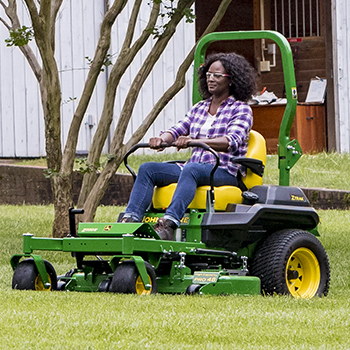 ZTrak Z720E Mower shown
ZTrak Z720E Mower shown
Formed and welded steel frame
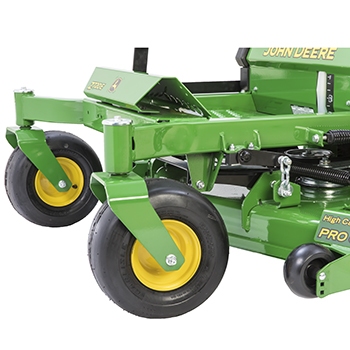 Solid steel tube front frame
Solid steel tube front frame
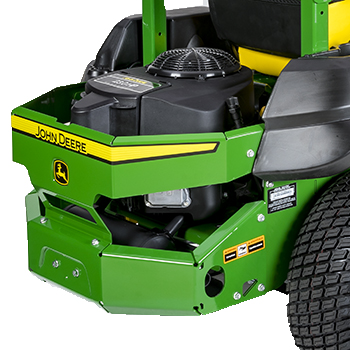 Strong rear frame for support and protection
Strong rear frame for support and protection
A strong, welded steel frame provides solid, reliable support for the machine components and operator:
- Heavy-duty 3- x 2-in. (76.2- x 51-mm) frame tubing for durability
- Rear frame provides solid support and protection for the engine
Large, smooth-riding front caster wheels
 Large caster wheel
Large caster wheel
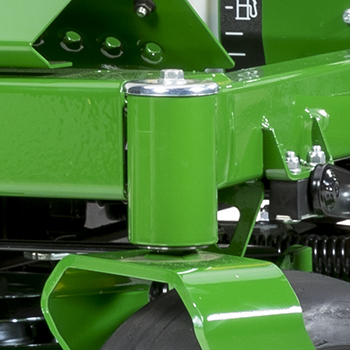 Caster wheel spindle housing
Caster wheel spindle housing
Large front caster wheels provide a smooth ride and level cut:
- A large surface area helps to provide a smooth ride for the operator.
- Pneumatic tires for the smoothest ride (Z720E, Z735E, Z730M, Z735M, Z740R)
- Semi-pneumatic tires for extra reliability and durability (Z740R with Tweel® tire technology)
- Better performance on slopes
- Caster wheels turn easily on two maintenance-free sealed ball bearings for both the spindles and the wheel axles.
- Long, trouble-free life
- Designed to give smooth turns without damage to the turf
Large rear drive wheels for a smooth ride and level cut
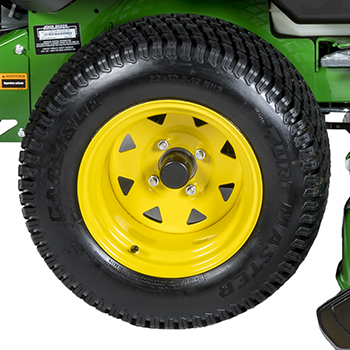 23-in. (58.4-cm) diameter rear tire (E and M Series)
23-in. (58.4-cm) diameter rear tire (E and M Series)
 24-in. (61-cm) diameter rear tire (Z740R)
24-in. (61-cm) diameter rear tire (Z740R)
Rear tires have high-quality tread and optimum size for superior traction and smooth ride:
- Tire width is optimized for mower deck size.
- 9.5 in. (24 cm) for 48-in. (122-cm) mowers (E, M, R Series)
- 10.5 in. (26.7 cm) for 54-in. (137-cm) and 60-in. (152-cm) mowers (E, M Series)
- 12 in. (30.5 cm) for 54-in. (137-cm) and 60-in. (152-cm) mowers (Z740R)
- Tread pattern is optimized for excellent traction and minimum turf damage.
- Special wheel design gives an enhanced appearance to the machine.
- Optional Michelin® X® Tweel Turf airless radial tire technology on the Z740R provides extra reliability and ride quality.
Standard two-post foldable Roll-Gard™ rollover protective structure (ROPS) increases operator safety
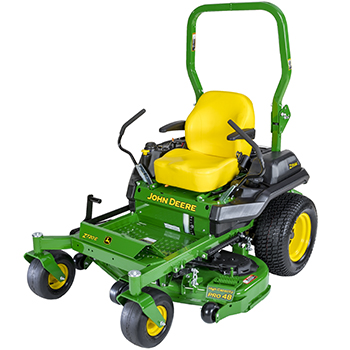 Clean, open operator station
Clean, open operator station
 Standard folding ROPS
Standard folding ROPS
The operator station has been designed for comfort, visibility, and ease of use:
- Operator station provides plenty of room for comfortable operation.
- Flat operator station makes getting on and off easy.
- Step weldment on mower deck is convenient for the operator.
- Controls are located close to the operator for convenience.
- Operator controls are color coded for easy identification and operation.
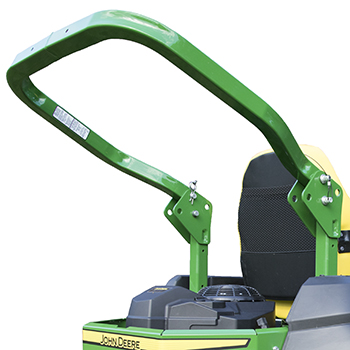 ROPS folded to mid position
ROPS folded to mid position
 ROPS folded to down position (hitch is base equipment on M and R Series; optional field installed kit on E Series)
ROPS folded to down position (hitch is base equipment on M and R Series; optional field installed kit on E Series)
ZTrak Z700 Series Mowers are equipped with a foldable Roll-Gard rollover protective structure (ROPS) and retractable seat belt:
- They help protect the operator in the event of tip over.
- Easy-fold ROPS improves the ability to store the ZTrak in a garage.
- The ROPS is designed to meet or exceed American Society of Agricultural Engineers (ASAE) safety standards.
- Easy-fold ROPS includes a built-in isolator.
- When the ROPS is up, the overall height is 71.1 in. (182.2 cm) for all models except the Z740R, which is 72.1 in. (183.2 cm).
- When the ROPS is down, the overall height is 47.4 in. (120.3 cm) for E Series, 49.7 in. (126.2 cm) for M Series, and 51 in. (129.5 cm) for R Series.
- To fold, remove the two pins and rotate the top of the Roll-Gard downward.
- The Roll-Gard must be in the upright and locked position when low clearance is not required.
- The ROPS and seat belt are included in base equipment.
- Use of the seat belt is recommended when operating with ROPS in the upright position.
Heavy-duty step weldment
 Step weldment on the mower deck
Step weldment on the mower deck
A heavy-duty, permanent step weldment is located at the left front corner of the mower deck:
- Encourages proper entry to the operator station
- Provides a good gripping surface for the operator’s foot
Michelin, X, and Tweel are trademarks of Michelin North America, Inc.
Three-position, adjustable foot platform to accommodate different size operators
 ZTrak™ Z720E Mower shown
ZTrak™ Z720E Mower shown
 ZTrak Z720E Mower shown
ZTrak Z720E Mower shown
An ergonomic design and professional grade components are suitable for a wide variety of operators and conditions:
- Comfortable operator station and convenient controls help optimize operator experience.
- Large operator platform allows a wide range of foot positions.
Adjustable features customize the mowing experience for each operator. One of these features is an adjustable foot platform.
Operator platform designed for adjustability and comfort
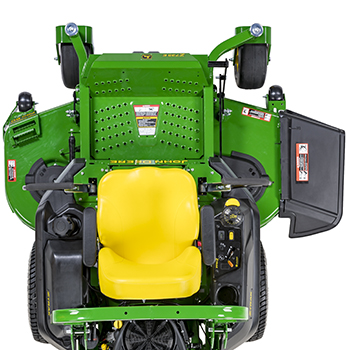 Operator station
Operator station
 Three-position foot platform for operator comfort, rearward position
Three-position foot platform for operator comfort, rearward position
The patent-pending, adjustable, three-position toe board allows the operator to quickly adjust the footrest position for greatest comfort:
- Easily and without tools, each operator can adjust the location of the footrest area to the optimum position.
- Adjustment range of 2 in. (5.1 cm) in 1-in. (2.5-cm) increments is possible.
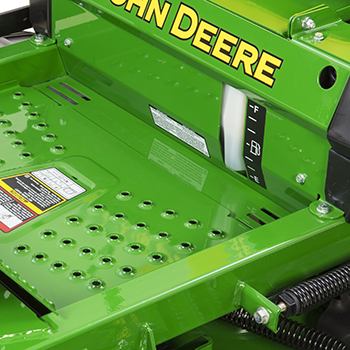 Adjustable foot platform, forward position
Adjustable foot platform, forward position
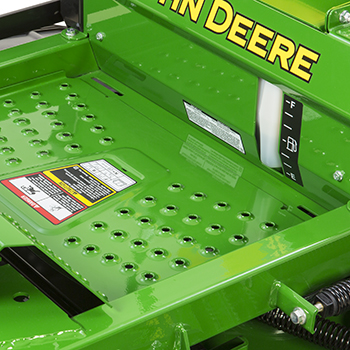 Adjustable foot platform, middle position
Adjustable foot platform, middle position
Short operators may be most comfortable with the platform in the rear position (as shown above), while tall operators may be more comfortable with the platform in the forward position. Or perhaps, the middle position provides just the right amount of leg room.
Foot pegs (standard on R Series, optional on E and M Series)
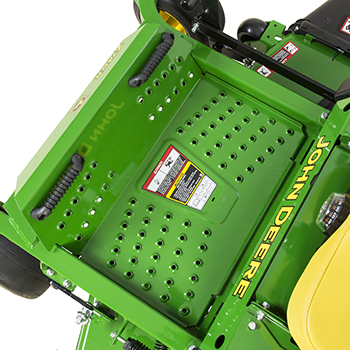 Foot platform with foot pegs
Foot platform with foot pegs
 Foot peg mounting holes
Foot peg mounting holes
Patent-pending foot pegs (standard on R Series, optional on E and M Series) provide the operator with different foot placement options.
- Foot pegs can be adjusted into two different positions, horizontal or at an angle, to provide more variability for foot placement. The pegs also act as handles to remove and replace the foot platform.
Smooth and powerful professional grade V-twin engine for performance and long life
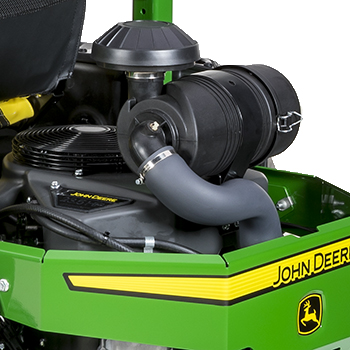 23.5-hp (17.5-kW) engine
23.5-hp (17.5-kW) engine
 Multi-stage canister air filter system
Multi-stage canister air filter system
Key engine features include:
- 23.5 hp (17.5 kW) provides plenty of power.
- Large 44.3-cu in. (726-cc) displacement provides excellent torque.
- V-twin, 90-degree cylinder design allows for easy starts, excellent power and performance, and smooth operation.
- Engine model is FX730V.
- Many quality features are included.
- Cast-iron cylinder liners provide a long-wearing surface for longer engine life.
- Overhead V-valves allow the engine to breathe easily for excellent power and fuel economy.
- Hemispherical combustion chambers and overhead V-valve technology help ensure low emissions, high power, and smooth operation.
- Automatic compression release provides easy starting.
 Engine debris chopper fan guard
Engine debris chopper fan guard
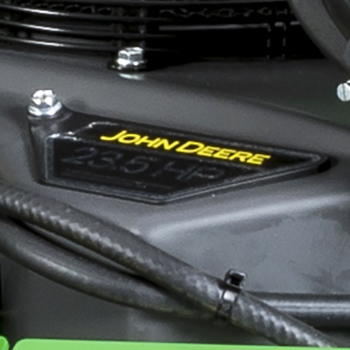 Engine integrated cleanout port
Engine integrated cleanout port
- A rotating metal grass chopper screen helps keep the engine fins clean by filtering out debris and reducing the size of material that gets through so it will pass harmlessly past the engine fins.
- The steel guard provides protection from the rotating fan.
- Integrated cleanout ports allow for checking and cleaning the engine cooling fins
 Engine oil check/fill and drain tube end
Engine oil check/fill and drain tube end
- Full-pressure lubrication system provides plenty of oil to the engines moving parts to ensure reliable operation and long life:
- No-tools oil drain is convenient to use.
- A flexible drain tube can be placed above a drain pan to eliminate oil spills.
- Replaceable oil filter keeps the oil cleaner for a longer engine life and extends the time between oil changes.
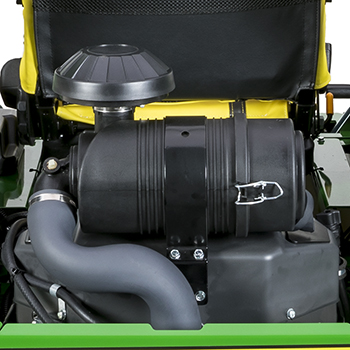 Heavy-duty canister air filter
Heavy-duty canister air filter
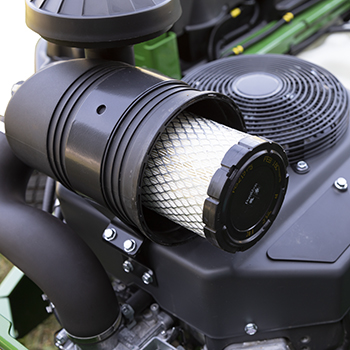 Air filter element
Air filter element
- Heavy-duty, multi-stage canister air filter system thoroughly cleans the engine intake air.
- Electronic ignition contributes to fast starts.
- Heavy-duty shift-type starter allows for fast starts, even in colder weather.
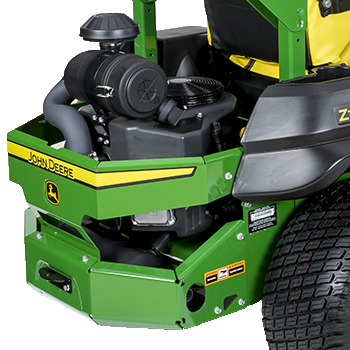 Rear engine guard
Rear engine guard
- A rear engine guard protects the engine and provides additional vehicle strength and integrity.
- A flywheel alternator provides plenty of capacity to quickly recharge the battery and power electrical equipment, such as lights or a sprayer.
- 20-amp capacity
- Regulated to keep the battery at a full charge without risk of overcharging
John Deere recommends the use of fuel stabilizer in gasoline. See Fuel-Protect for gasoline engines (8 oz [237 mL]) for more information.
8-gal. (30.3-L) fuel capacity for extended mowing times
 Easy-to-see fuel sight gauge
Easy-to-see fuel sight gauge
 Large fuel-fill opening
Large fuel-fill opening
The large-capacity fuel tank is easy to fill, and a convenient fuel level gauge is provided:
- Holds 8-gal. (30.3-L) of fuel to reduce time needed for refills
- Easy to see how much fuel is in the tank by viewing the sight gauge when approaching from the front of the machine
- Large, 3.5-in. (8.9-cm) fuel fill diameter for easy filling and minimum chance of spills
- Fuel fill is low for easy filling, within easy reach of any operator
John Deere recommends the use of fuel stabilizer in gasoline. See Fuel-Protect for gasoline engines (8 oz [237 mL]) for more information.
Transmission offers speeds up to 10 mph (16.1 km/h) to maximize mowing efficiency
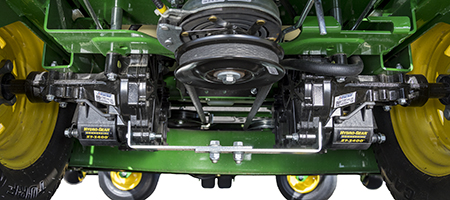 Dual Hydro-Gear® transmissions
Dual Hydro-Gear® transmissions
Dual transmissions efficiently power the ZTrak™ mower forward and reverse and give steering capability:
- The unitized hydrostatic drive features a hydraulic pump combined with a commercial-grade, heavy-duty wheel motor into a single unit.
- One pump and one motor transmission to drive each wheel provides several benefits:
- Exceptional cooling in high-load conditions
- Easy-to-check fluid level and refill with hydraulic oil
- Opens up access under the seat
- Transmissions are set low in the vehicle for excellent hillside stability.
- Heavy-duty components stand up to the higher loads from the larger tires and greater weight of Z700 Series ZTrak Mowers.
- Low maintenance, unitized transmissions are sealed and have no hose connections to leak hydraulic fluid.
- Four-bolt hubs provide a reliable and convenient wheel-mounting system.
The hydrostatic drive features two Hydro-Gear ZT-3400 transmissions for superior performance and durability:
- Unitized hydraulic pumps and commercial-grade, heavy-duty wheel motors combined into a single unit
- Speeds up to 10 mph (16.1 km/h)
- Pump displacement: 0.73 cu in. (12 cc) per revolution
- Motor displacement: 0.97 cu in. (16 cc) per revolution
- Durable 1-in. (2.54-cm) axles for heavy loads
- Standard shock valves for added system protection
- Standard charge pump for increased performance
- External oil filter for easier maintenance
Expansion tanks and tow valve controls
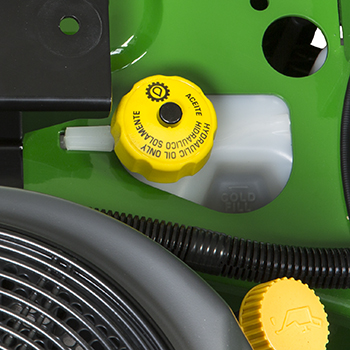 Transmission expansion tank and filler cap
Transmission expansion tank and filler cap
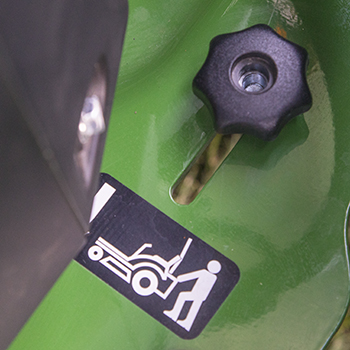 Tow-valve control, right
Tow-valve control, right
Transmission fluid expansion tanks are provided for each transmission. The yellow filler cap is easy to find and identify.
Tow-valve controls are provided for each transmission:
- Controls are located on the transmissions near the expansion tanks where they are easy to reach and use.
- Tow valves allow moving the machine in its neutral position when the engine is not running.
- Simply pull up on the rods and secure them into the slot. When finished moving the machine, return the rods to the operating position.
Hydro-Gear and ZT-3400 are trademarks of Hydro-Gear Limited Partnership AF Holding Company, a Delaware Corporation and Danfoss Power Solutions (US) Company, a Delaware Corporation
Optional Michelin® X® Tweel® Turf airless radial tire technology on the Z740R for extra reliability and ride quality
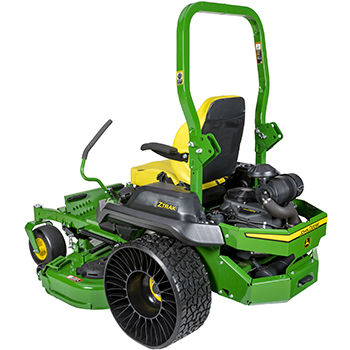 Z740R with flat-free rear tires
Z740R with flat-free rear tires
NOTE: Michelin X Tweel tires are available only in the 24x12N12 size for Z740R Mowers equipped with a 54-in. (137-cm) or 60-in. (152-cm) Mower Deck.
Michelin is a world leader in tire manufacturing and technology. This airless radial tire solution gives additional advantages.
Advantages of using the Michelin X Tweel Turf tires include:
- More comfortable ride because of less bounce.
- Mowing performance is improved.
- Rutting is reduced because the Michelin X Tweel Turf has more support across the surface for improved flotation and better ground contact.
- Unique energy transfer within the poly-resin spokes reduces the bounce associated with pneumatic tires.
- Excellent curb climbing is possible due to the Michelin X Tweel Turf construction and flexibility.
- More consistent cut quality is achieved because inconsistent tire pressure is eliminated.
- Uptime is improved.
- The exclusive technology eliminates downtime and associated cost due to flat or damaged tires.
- Punctures and sidewall damage no longer result in downtime.
- Cost of operation is reduced.
- Cost of repairs and maintenance is reduced.
- One single unit replaces the current tire, wheel, and valve assembly.
- There is no need for complex tire-mounting equipment.
- No need to spend time checking and optimizing tire pressure.
- The need to purchase and stock plug kits and spare tires is eliminated.
- The tire tread will last up to three times longer than current pneumatic tires because automotive-grade rubber is used for the tread.
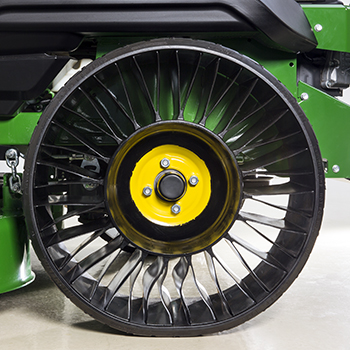 Michelin X Tweel Turf tire, side
Michelin X Tweel Turf tire, side
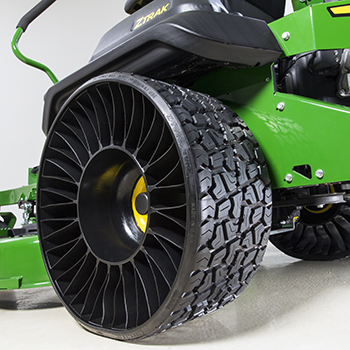 Michelin X Tweel Turf tire, left rear
Michelin X Tweel Turf tire, left rear
Heavy-duty construction provides the ultimate in performance and reliable operation:
- High-strength poly-resin spokes carry the load.
- Four-hole, heavy-duty steel hub easily bolts onto a Z740R equipped with a 54-in. (137-cm) or 60-in. (152-cm) Mower Deck and 24x12-12 tires.
- Michelin X Tweel tires are not available for machines with a 48-in. (122-cm) Mower Deck.
- Deep, open-tread design provides excellent cleaning and traction.
- Zero degree, high-tensile proprietary carcass provides great lateral stiffness while resisting damage from impact and penetration.
Michelin, X, and Tweel are trademarks of Michelin North America, Inc.
Operator station is adjustable for superior comfort
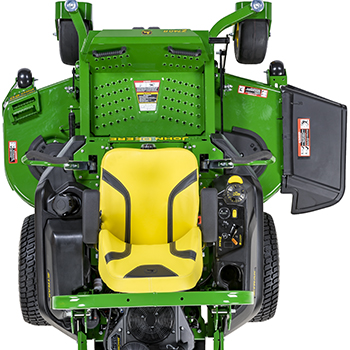 Operator station
Operator station
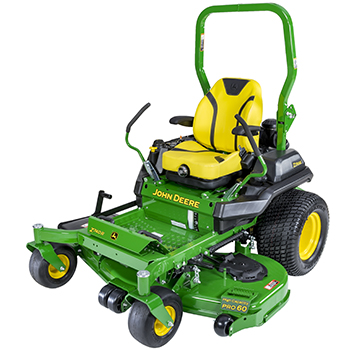 Fully-adjustable operator area
Fully-adjustable operator area
The operator station is designed to provide superior operator comfort:
- Adjustable foot platform
- Three positions allow for ample legroom
- Adjustable seat position, armrests, and suspension to suit any operator
- A dial can be adjusted to the operator’s weight
- Adjustable motion-control levers
- Upper and lower positioning combined with forward and rearward tilt offers 18 positions
- Large, padded areas on the control levers provide multiple hand positions
- Upper and lower positioning combined with forward and rearward tilt offers 18 positions
Adjustable operator foot platform
 Adjustable foot platform
Adjustable foot platform
 Foot platform with standard foot pegs
Foot platform with standard foot pegs
The patent-pending, adjustable three-position toe board allows any operator to quickly adjust the footrest position for greatest comfort.
- Easily and without tools, each operator can adjust the location of the footrest area to the most suitable position.
- Adjustment range of 2 in. (5.1 cm)
- Large foot platform allows a wide range of foot positions.
- Patent-pending foot pegs are standard on the Z740R (optional on E and M Series) to provide the operator more foot placement options.
- They can be adjusted into two different positions, horizontal and at an angle, providing more variability for foot placement during operation.
- The foot pegs also act as handles to remove and replace the foot platform.
Adjustable, mechanical suspension seat
 Mechanical suspension seat with armrests
Mechanical suspension seat with armrests
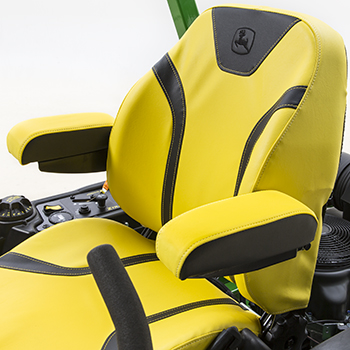 Padded armrest option installed
Padded armrest option installed
High-back, 24-in. (61-cm) seat with armrests and 4-in. (10.2-cm) fore-aft adjustment is standard equipment on the Z740R.
Optional padded armrests are available as a field-installed kit.
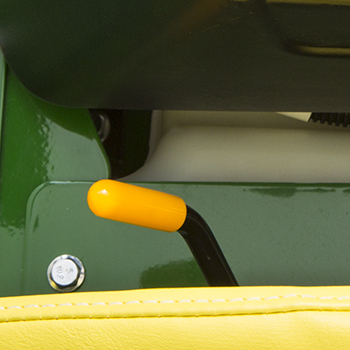 Seat slide fore/aft adjustment lever
Seat slide fore/aft adjustment lever
 Spring-loaded seat latch
Spring-loaded seat latch
The mechanical suspension seat is easier to adjust when off of the mower, but it can also be adjusted while the operator is seated. Fore/aft seat adjustment lever is alongside the seat within easy reach and can be used by the operator while seated.
The seat is securely held down for operator comfort and safety, but is easy to raise when necessary:
- A spring-loaded latch locks seat down when it is lowered.
- The seat is easy to release and raise to access several service points.
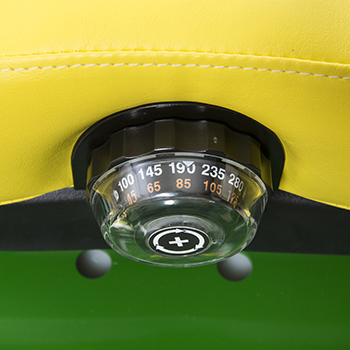 Seat suspension adjustment knob
Seat suspension adjustment knob
There is an adjustment knob at the front of the seat which can be dialed-in to suit operator preference and for the most comfortable ride. It is recommended to align the arrow on the dial with the operator’s weight for the optimal ride.
Additional information about the seat is available at: Adjustable, mechanical suspension seat for a smooth ride
Adjustable steering levers
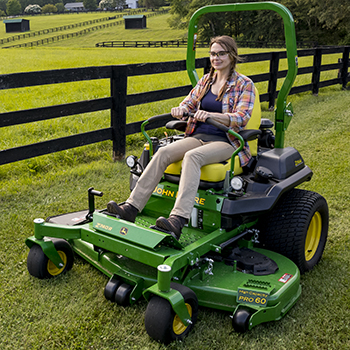 Z740R mowing
Z740R mowing
 Steering levers shown in neutral/operating position
Steering levers shown in neutral/operating position
Adjustable steering levers are shaped for operator comfort and ease of controlling vehicle speed and direction:
- The premium steering levers on M and R Series machines are painted green and have different bends for more hand positions.
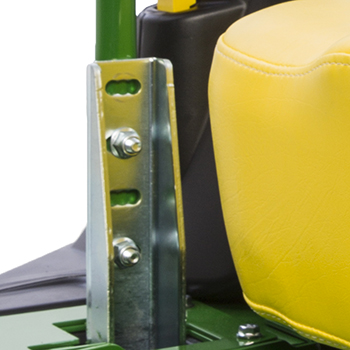 Steering lever adjustments, low position
Steering lever adjustments, low position
 Steering lever adjustments, high position
Steering lever adjustments, high position
- The levers offer 18 different positions for height and position to accommodate operator preference for hand placement and leg clearance.
Cup holder and storage compartment
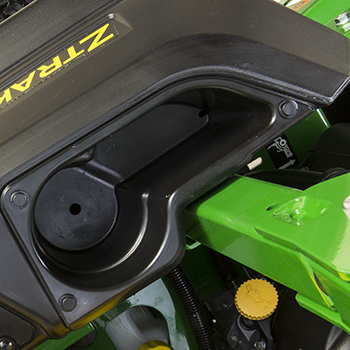 Deluxe cup holder with provision for cup handle
Deluxe cup holder with provision for cup handle
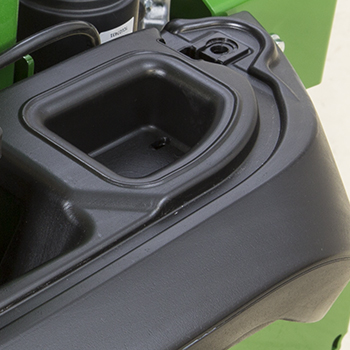 Protected-storage compartment shown with battery cover removed
Protected-storage compartment shown with battery cover removed
Operator convenience is provided with easy-to-reach and easy-to-use deluxe cup holder and storage areas:
- Cup holder includes room for a cup with a large handle.
- Covered storage compartment under the battery access panel provides protection for smaller items.
Adjustable, mechanical suspension seat for a smooth ride
 Mechanical suspension seat with armrests
Mechanical suspension seat with armrests
 Z740R seat shown with padded armrest attachment
Z740R seat shown with padded armrest attachment
High-back, 24-in. (61-cm) seat with armrests and 3-in. (7.6-cm) fore-aft adjustment is standard equipment on the Z740R.
An optional padded armrest kit is available as a field-installed attachment.
 Seat suspension adjustment dial
Seat suspension adjustment dial
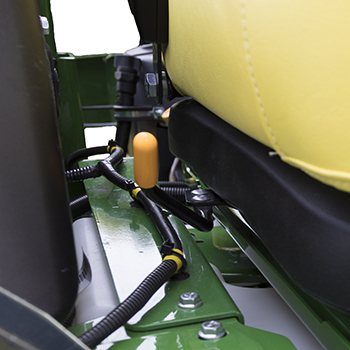 Seat slide fore/aft adjustment lever
Seat slide fore/aft adjustment lever
The mechanical suspension seat can be adjusted for operator weight and ride preference while the operator is seated.
A fore/aft seat adjustment lever is alongside the seat within easy reach and can be used by the operator while seated. The seat adjusts 3 in. (7.6 cm) fore and aft.
 Spring-loaded seat latch
Spring-loaded seat latch
The seat is securely held down, but is easy to raise when necessary:
- A spring-loaded latch locks seat down when it is lowered.
Controls, including an automatic motion-control lever/parking brake system, are easy to find and use
Control panel
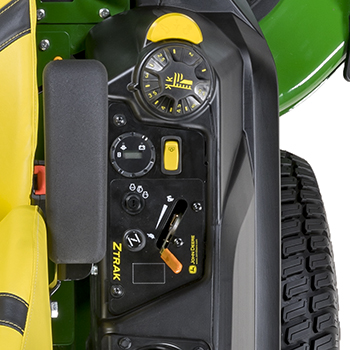 Control panel, Z740R includes warning lights
Control panel, Z740R includes warning lights
 Digital display
Digital display
The operator control panel is conveniently located and easy to use.
The following controls are found on the right-hand console:
- Digital display
- Hour meter
- Warning light for low oil pressure
- Warning light for alternator/battery charge malfunction
- Ignition switch
- Power take-off (PTO) control
- Engine speed control
- Engine choke control
- Mower cut-height dial
- Mower transport position lock
- Space for an optional light kit switch
Adjustable steering levers
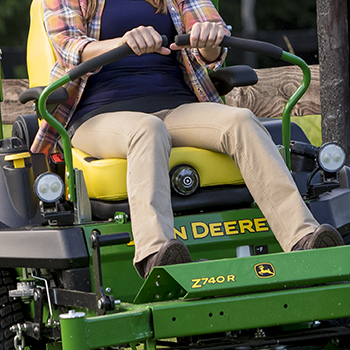 Motion-control levers in operating position (optional light kit shown)
Motion-control levers in operating position (optional light kit shown)
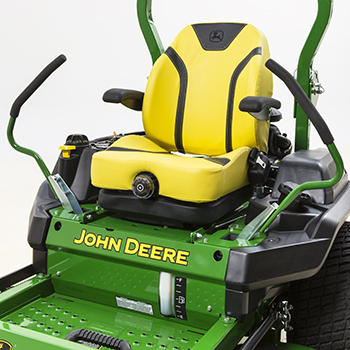 Motion-control levers in park position
Motion-control levers in park position
Motion control levers are shaped and located for operator comfort and ease of control.
Premium control levers on the Z730M, Z735M, and Z740R have a unique shape and size for more comfortable operation.
 18-position control lever adjustment, low
18-position control lever adjustment, low
 18-position control lever adjustment, high
18-position control lever adjustment, high
The motion-control levers can be adjusted to two different height settings and nine different fore-aft settings:
- Combined height and fore/aft adjustments provide 18 positions
- Increased operator comfort with more leg room and more hand positions
- Adjustable for most precise control of the machine
Tracking adjustment
On-board tracking adjustment can be made by the operator from the operator seat.
- A 13-mm socket wrench is required.
Parking brake integrated with motion-control levers for extra convenience
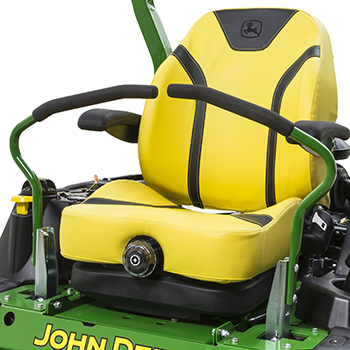 Parking brake in disengaged/neutral position
Parking brake in disengaged/neutral position
A patent-pending automatic parking brake system is designed into the steering control levers:
- The mechanical parking brake is operated by the steering control levers.
- The parking brake is engaged when the steering control levers are moved outward, and it is disengaged when the steering control levers are moved inward to the operating position.
- An audible click lets the operator know the brake has fully engaged or disengaged.
The internal parking brake rotor and puck are continually lubricated and cooled for dependable operation and long life.
Mower deck lift/cut-height adjustment
 Mower deck lift pedal
Mower deck lift pedal
 Mower lift-assist spring
Mower lift-assist spring
Mower deck cutting height adjusts from 1.5 in. (3.8 cm) to 5 in. (12.7 cm) in 0.25-in. (0.64-cm) increments for excellent cut quality and performance:
- The foot-lift pedal is used to raise the mower deck for setting cut height or locking in the raised or transport position.
- A lift-assist spring is provided to optimize the effort required to raise the mower deck.
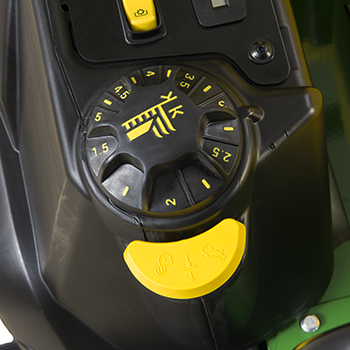 Mower deck cut-height adjustment dial
Mower deck cut-height adjustment dial
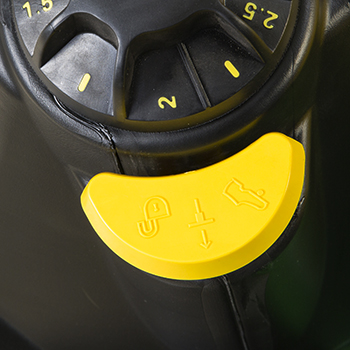 Mower deck transport lock
Mower deck transport lock
- To adjust cut height, simply push down on the foot-lift pedal, adjust the dial, and release the foot-lift pedal to lower the deck to the chosen height.
- Use the foot-lift pedal to lock the deck in transport mode. Simply depress the pedal all the way and the deck will lock into transport mode.
- To unlock and lower the deck, push down on the foot-lift pedal, pull up on the transport unlock lever and release the foot-lift pedal to lower the deck to the chosen height.
Safety interlock system
 Interlock switch is located under the seat
Interlock switch is located under the seat
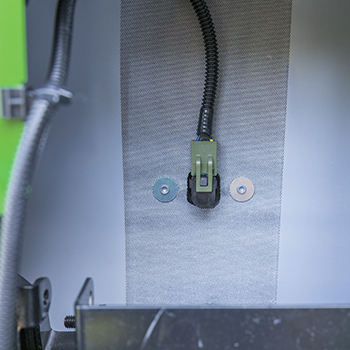 Seat raised to show operator presence switch
Seat raised to show operator presence switch
Safety interlocks help prevent operating in an unsafe way:
- The parking brake must be engaged for the engine to crank.
- Parking brake is set when motion-control levers are in the outward position.
- The operator presence system requires the operator to be in the seat to operate the PTO.
- The key switch interlock prevents bypass starting.
- If the operator leaves the seat when the PTO is engaged, controls are in the operating position, or the parking brake is not set, the engine will shut down.
- The seat interlock switch disengages the mower when the operator leaves the seat.
- The engine will stall if the operator leaves the seat without the motion-control levers in the outward position and the parking brake set.
Serviceability is designed-in for convenience
4-year bumper-to-bumper warranty*
Exclusive, 4-year, single-source, bumper-to-bumper warranty is included for all John Deere Z700 Series ZTrak mowers. The warranty places John Deere at the forefront of the mowing industry. It is hassle free, with one company handling all of the paperwork.
Z720E, Z735E |
4-year, 500-hour warranty |
Z730M, Z735M |
4-year, 750-hour warranty |
Z740R |
4-year, 1000-hour warranty |
Service interval decal
 Daily service decal
Daily service decal
A convenient service decal gives basic maintenance information. It provides a quick reference for keeping recommended service up to date. It is located underneath the battery cover.
Flip-up foot platform for mower deck access
 Operator foot platform
Operator foot platform
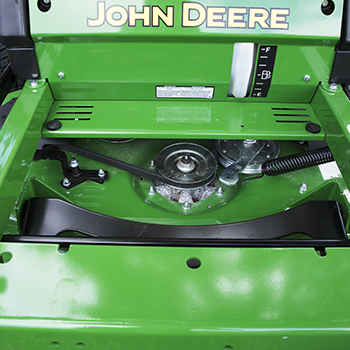 Easy-to-remove foot platform (Z720E shown)
Easy-to-remove foot platform (Z720E shown)
The professional-style steel foot platform is easy to remove without tools:
- Makes cleaning grass off the top of the mower deck easier
- Provides convenient access to the mower deck for service
Engine service
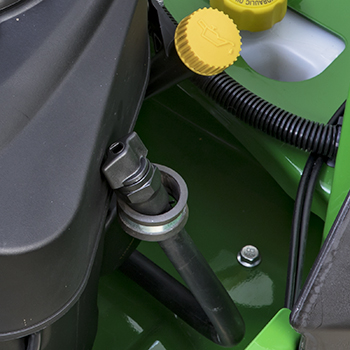 Engine oil check/fill and drain tube (Z720E, Z730M, Z740R)
Engine oil check/fill and drain tube (Z720E, Z730M, Z740R)
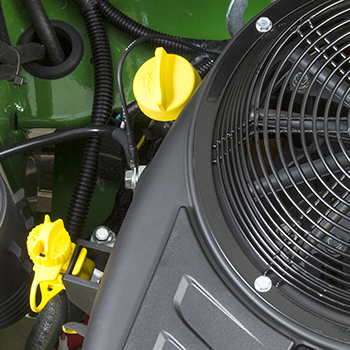 Engine oil check/fill and drain tube (Z735E, Z735M)
Engine oil check/fill and drain tube (Z735E, Z735M)
The engines are easy to service, including changing the oil and the oil filter and servicing the air filter:
- The engine oil check/fill tube is located at the top of the engine and easy to see and reach.
- No-tools oil drain is convenient to use. A flexible oil drain tube is included to conveniently drain oil into a pan, thus eliminating oil spills.
 Engine air filter panel (Z735E engine shown)
Engine air filter panel (Z735E engine shown)
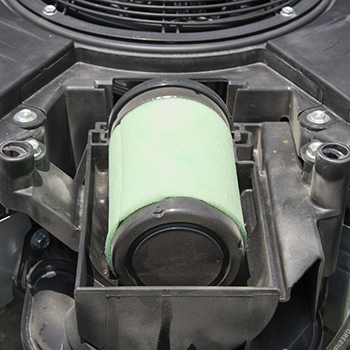 Air filter cover removed (Z735E shown)
Air filter cover removed (Z735E shown)
 Multi-stage canister air filter system (Z740R shown)
Multi-stage canister air filter system (Z740R shown)
 Air filter element (Z740R shown)
Air filter element (Z740R shown)
Engine air filters are at the top of the engine for easy service:
- Z720E, Z735E, Z730M, and Z735M engines have knobs to remove the filer cover.
- The Z740R has a heavy-duty, multi-stage canister air filter system, which uses a round primary and secondary filter that are easily accessed with latches on the end cap.
Grease fittings
 Top of the mower deck
Top of the mower deck
Only three grease fittings require service:
Three to lubricate the mower-blade spindles, two easily accessed from the spindle covers, and the third by removing the foot platform.
Battery accessibility
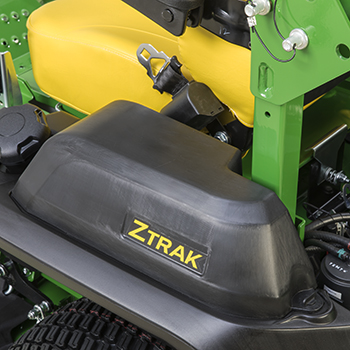 Battery cover
Battery cover
 340 CCA battery
340 CCA battery
The battery is protected from debris, dust, and moisture:
- It is easy to access under the panel on the left-hand side of the machine.
- Held in place by an easy-to-remove thumbscrew
- Powerful 340 cold cranking amp (CCA) battery provides dependable starts.
 Easy-to-clean flat-top mower deck
Easy-to-clean flat-top mower deck
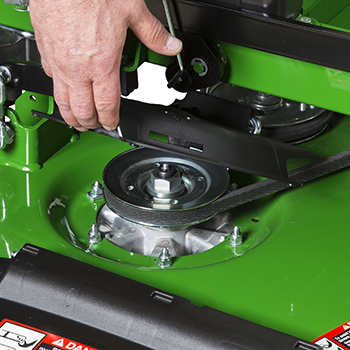 Flip-up spindle cover for easy cleanout and maintenance
Flip-up spindle cover for easy cleanout and maintenance
Serviceability is designed into the mower deck:
- Easy access is provided by the removable operator foot platform.
- Flat-top design minimizes places for debris to collect.
- Spring-loaded, flip-up belt guards make removing debris easy.
- A provision is provided for a standard, 3/8-in. (9.5-mm) ratchet wrench to be used for releasing belt tension when removing the drive belt.
Mower deck serviceability
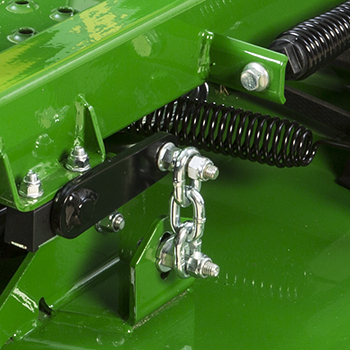 Floating deck mounting system
Floating deck mounting system
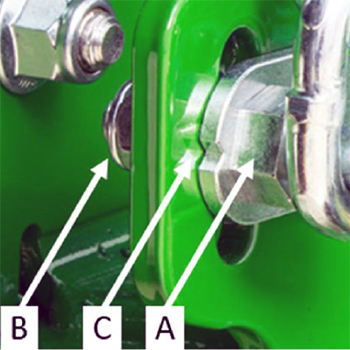 Deck-level adjustment
Deck-level adjustment
A patent-pending deck-leveling system provides easy adjustment at all four mower mounting points:
- Loosen the nut (B) slightly with a 15-mm wrench.
- Using the open end of a 16-mm wrench on the hex fastener (A), raise or lower the deck as needed so the height of the rear blade tip is 3 to 6 mm (1/8 to 1/4 in.) higher than the front blade tip.
- Tick marks on bracket (C) are provided to aid in observing movement.
- When the deck is at the height needed, tighten the nut (B).
Transmission bypass (tow valves)
 Tow-valve control, right (knob pictured in neutral position)
Tow-valve control, right (knob pictured in neutral position)
Tow-valve controls are provided for each transmission:
- Controls are located at the rear of the machine and are easy to access.
- Tow valves allow moving the machine in its neutral position when the engine is not running.
- Simply, loosen the knob, push towards the front of the machine, and tighten the knob back. When finished moving the machine, return the rods to the operating position.
Built-in tie-down locations
 Built-in front tie-down location, right side
Built-in front tie-down location, right side
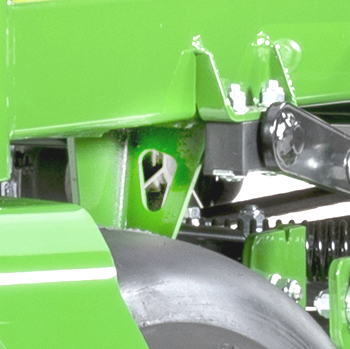 Built-in front tie-down location, left side
Built-in front tie-down location, left side
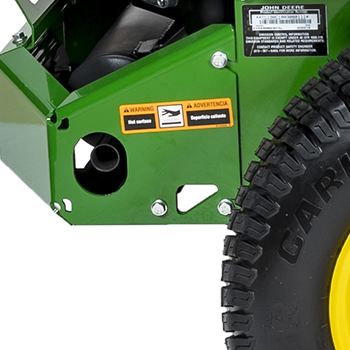 Built-in rear tie-down location, right side
Built-in rear tie-down location, right side
 Built-in rear tie-down location, left side
Built-in rear tie-down location, left side
Four tie-down locations are provided for convenience and safety when trailering the machine.
Operator digital video disc (DVD)
An operation and safety DVD is provided with each machine. Please consult the operator’s manual for other safety and operating procedures.
*Term limited to years or hours used, whichever comes first, and varies by model. See the LIMITED WARRANTY FOR NEW JOHN DEERE TURF AND UTILITY EQUIPMENT at JohnDeere.com or JohnDeere.ca/TUWarranty for details.
High-capacity (HC) PRO Mower Decks offer superior cut quality and versatility
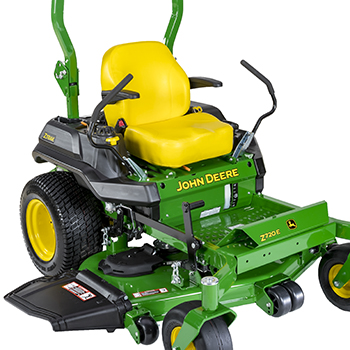 Z720E with 54-in. (137-cm) HC PRO Mower Deck
Z720E with 54-in. (137-cm) HC PRO Mower Deck
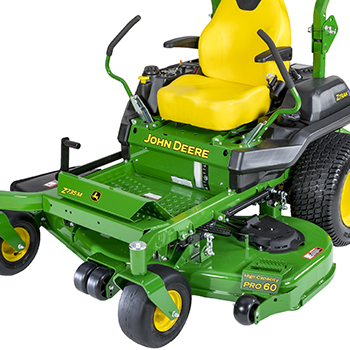 Z735M with 60-in. (152-cm) HC PRO Mower Deck
Z735M with 60-in. (152-cm) HC PRO Mower Deck
Each Z700 Series ZTrak™ Mower is equipped with either a 48-in. (122-cm), 54-in. (137-cm), or 60-in. (152-cm) HC PRO Mower Deck.
Mower/vehicle compatibility
| High-capacity (HC) mower deck | ZTrak model | |||||
| Z720E | Z735E | Z730M | Z735M | Z740R | Z740R with Tweel® tire technology | |
| 48-in. (122-cm) High-capacity PRO | X | X | X | |||
| 54-in. (137-cm) High-capacity PRO | X | X | X | X | X* | |
| 60-in. (152-cm) High-capacity PRO | X | X | X | X | X | X* |
*Not compatible with material collection system (MCS)
Deep deck design
 Deep, flat-top deck
Deep, flat-top deck
 Deep-deck mower design
Deep-deck mower design
The mower deck has a deep-deck design:
- Constructed from heavy, 9-gauge, 0.15-in. (3.8-mm) steel.
- Minimizes the number of welds required
- Has a smooth underside for reduced material buildup
- Deep-deck design delivers excellent airflow, so large volumes of material can be processed quickly and efficiently.
- A wider and higher discharge opening provides even clipping dispersal for an excellent finished appearance in all conditions.
- A durable plastic deflector spreads grass clippings evenly across the lawn, is hinged, and can be raised to minimize the storage space required.
- 1-in. (25.4-mm) cold-forged spindles are heat-treated for strength and are supported by ball bearings.
- Standard front rollers and two double-captured wheels provide a more even mowing job and reduce the chance of scalping.
- Adjustable for different mowing heights
- The front edge is raised above the blade plane to allow for even cutting of tall grass.
- Blade overlap is greater than many conventional decks for a clean cut.
- The mower can side-discharge, mulch, or collect material, except a Z740R equipped with Tweel tires is not compatible with a material collection system.
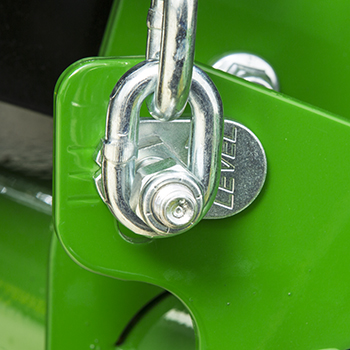 Mower level adjustment
Mower level adjustment
- Deck leveling and rake angle adjustment is provided at all four mower mounting points.
Step weldment
 Operator step welded on mower deck
Operator step welded on mower deck
A permanent step weldment is located at the left front corner of the mower deck:
- Encourages proper entry to the operator station
- Provides a good gripping surface for the operator’s foot
Reinforced leading edge
 Reinforced leading edge of mower deck
Reinforced leading edge of mower deck
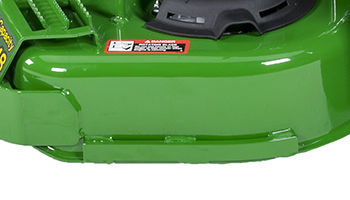 Trim side of mower reinforcement/wear bar
Trim side of mower reinforcement/wear bar
Steel reinforcing bars are welded to the front edge and trim side of the mower deck:
- Strengthens the deck to reduce chance of damage from obstructions
- Increased material thickness for longer life of the deck
Superior durability is designed in
 Deep mower deck spindle pocket
Deep mower deck spindle pocket
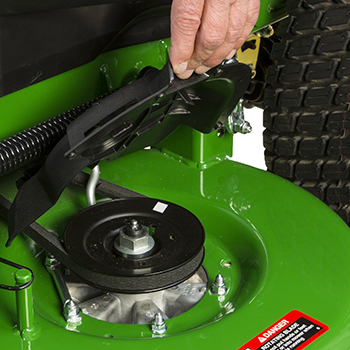 Flip-up spindle cover
Flip-up spindle cover
The deck has deep, strong spindle pockets to keep the blades aligned, even after years of tough operation:
- Ribs formed in the deck shell add strength where it is needed.
- The aluminum spindle housing has 8-in. (20-cm) base for extra strength.
Flip-up spindle covers make cleaning the spindle area convenient.
Wheels and rollers
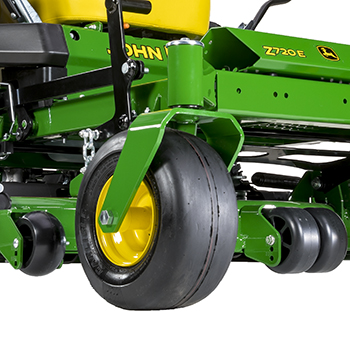 Right mower anti-scalp wheel and center rollers
Right mower anti-scalp wheel and center rollers
 Left mower anti-scalp wheel
Left mower anti-scalp wheel
Dual-captured front and side anti-scalp wheels:
- Give a more even mowing job and reduce the chance of scalping
- Adjustable for different mowing heights
Optional MulchControl™ attachment
The MulchControl attachment makes mulching more practical for many mowing situations because it not only does an excellent job of mulching but it also allows the mower to be easily converted for times when it is more desirable to side discharge or collect the lawn material.
Advantages of mulching grass clippings include:
- A beautiful looking lawn
- Grass clippings not blown onto the operator, driveways, or flower beds
- Less fertilizer use
- Elimination of the effort needed to dispose of clippings
How MulchControl works
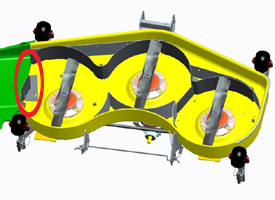 Illustration of MulchControl baffle open
Illustration of MulchControl baffle open
 Illustration of MulchControl baffle closed
Illustration of MulchControl baffle closed
MulchControl is an innovative, simple design that is easy to use and maintain:
- The MulchControl attachment includes baffles to control the flow of material under the deck.
- The left mower blade area is completely enclosed and optimized for mulching and will mulch even when the mower is in the side-discharge mode.
- Baffles around the center and right blades are optimized for mulching when the discharge baffle is closed.
- The attachment also includes mulching blades.
Optional 6.5-bu (229-L) ZTrak Z700 Series MCS
 6.5-bu (230-L) hopper and included weights (chute, blower and attachment bar sold separately)
6.5-bu (230-L) hopper and included weights (chute, blower and attachment bar sold separately)
 6.5-bu (230-L) rear hopper, chute, attachment bar, and blower
6.5-bu (230-L) rear hopper, chute, attachment bar, and blower
The 6.5-bu (230-L) rear bagger efficiently collects material from a 48-, 54-, or 60-in. (122-, 137-, or 152-cm) Mower Deck:
- Hopper, attachment bar/bumper, Power Flow™ blower, and chute components are ordered separately to make a complete MCS.
- A weight bracket and four 18-lb (8.2-kg) weights are included for installation on the front of the vehicle to help counterbalance the weight of the hopper. For proper ballast with complete MCS:
- Four weights are required on a ZTrak Z700 Series equipped with a 48-in. (122-cm) Mower Deck.
- Three weights are required on a ZTrak Z700 Series equipped with a 54-in. (137-cm) Mower Deck.
- Two weights are required on a ZTrak Z700 Series equipped with a 60-in. (152-cm) Mower Deck.
MulchControl handle is used to control baffle
 MulchControl baffle closed
MulchControl baffle closed
 MulchControl handle in closed position
MulchControl handle in closed position
The MulchControl handle is located on top of the mower deck and used to open and close the discharge baffle:
- The operator is required to get off of the machine in order to engage or disengage mulch mode.
- MulchControl is well suited to the following mowing situations:
- Operators who usually mulch, but side-discharge when grass gets too long
- Operators who usually side discharge, but would like to be able to close the chute to control clippings
- Operators who always mulch a main lawn, but often side discharge secondary lawns
- Operators who bag clippings, but want to go farther before emptying bags
MulchControl puts the operator in control of the clippings. The operator can have all the benefits of mulching with the ability to easily change to side-discharge or bagging when needed.
MulchControl limitations
While in the side-discharge mode, MulchControl will still mulch about one third of the material. Therefore, the side-discharge mode is essentially a partial-mulch mode. This can be an advantage when side discharging or bagging, as it helps to reduce the amount of material being discharged. Other times this could work as a disadvantage:
- When cutting strong southern grasses, such as Zoysia and Bermuda
- When cutting in wet, high-growth conditions, such as those found in the Pacific Northwest United States
- When optimum bagging and lawn clean-up is desired
Compatibility
MulchControl is a field-installed attachment and compatible with the 48-in. (122-cm), 54-in. (137-cm), and 60-in. (152-cm) HC PRO Mower Decks available for the Z700 Series ZTrak Mowers.
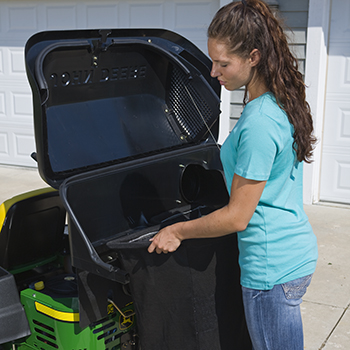 Removing bag from 6.5-bu (230-L) hopper
Removing bag from 6.5-bu (230-L) hopper
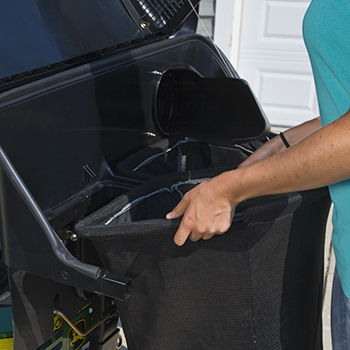 Removing bag from 6.5-bu (230-L) hopper
Removing bag from 6.5-bu (230-L) hopper
The hopper design provides efficient bagging performance, clean operation, and easy-to-empty bags:
- Two durable bags give a generous, 6.5-bu (230-L) capacity.
- The bags lift out for easy emptying.
- An efficient chute provides a smooth flow of material to reduce the chance of plugging.
- The chute and Power Flow blower must be ordered separately.
- Standard mower blades are used for bagging.
- The air exhaust duct directs air from the hopper back and toward the ground for clean operation.
- Convenient latch makes opening and closing the hopper easy.
NOTE: Appropriate hopper, Power Flow blower, chute, and attachment bar are required and ordered separately.
Specifications
Capacity |
6.5 bu (230 L) |
Material: |
|
Hopper top |
High impact polypropylene |
Chute |
Polyethylene |
Blower housing |
Nylon |
Fan |
Ultra-high molecular weight (UHMW) polyethylene |
Bags |
Polyester |
Filling |
Directly into bags for emptying on ground or in trailer or into plastic liners |
Fan diameter |
13 in. (33 cm) |
Fan width |
2.75 in. (7 cm) |
Number of fan blades |
Four |
NOTE: MulchControl attachments and MCS components are not included in base equipment for a Z700 Series ZTrak machine and must be ordered separately.
Tweel is a trademark of Michelin North America, Inc.
Features
Heavy-duty design delivers strength and durability
 ZTrak™ Z720E Mower shown
ZTrak™ Z720E Mower shown
 ZTrak Z720E Mower shown
ZTrak Z720E Mower shown
Formed and welded steel frame
 Solid steel tube front frame
Solid steel tube front frame
 Strong rear frame for support and protection
Strong rear frame for support and protection
A strong, welded steel frame provides solid, reliable support for the machine components and operator:
- Heavy-duty 3- x 2-in. (76.2- x 51-mm) frame tubing for durability
- Rear frame provides solid support and protection for the engine
Large, smooth-riding front caster wheels
 Large caster wheel
Large caster wheel
 Caster wheel spindle housing
Caster wheel spindle housing
Large front caster wheels provide a smooth ride and level cut:
- A large surface area helps to provide a smooth ride for the operator.
- Pneumatic tires for the smoothest ride (Z720E, Z735E, Z730M, Z735M, Z740R)
- Semi-pneumatic tires for extra reliability and durability (Z740R with Tweel® tire technology)
- Better performance on slopes
- Caster wheels turn easily on two maintenance-free sealed ball bearings for both the spindles and the wheel axles.
- Long, trouble-free life
- Designed to give smooth turns without damage to the turf
Large rear drive wheels for a smooth ride and level cut
 23-in. (58.4-cm) diameter rear tire (E and M Series)
23-in. (58.4-cm) diameter rear tire (E and M Series)
 24-in. (61-cm) diameter rear tire (Z740R)
24-in. (61-cm) diameter rear tire (Z740R)
Rear tires have high-quality tread and optimum size for superior traction and smooth ride:
- Tire width is optimized for mower deck size.
- 9.5 in. (24 cm) for 48-in. (122-cm) mowers (E, M, R Series)
- 10.5 in. (26.7 cm) for 54-in. (137-cm) and 60-in. (152-cm) mowers (E, M Series)
- 12 in. (30.5 cm) for 54-in. (137-cm) and 60-in. (152-cm) mowers (Z740R)
- Tread pattern is optimized for excellent traction and minimum turf damage.
- Special wheel design gives an enhanced appearance to the machine.
- Optional Michelin® X® Tweel Turf airless radial tire technology on the Z740R provides extra reliability and ride quality.
Standard two-post foldable Roll-Gard™ rollover protective structure (ROPS) increases operator safety
 Clean, open operator station
Clean, open operator station
 Standard folding ROPS
Standard folding ROPS
The operator station has been designed for comfort, visibility, and ease of use:
- Operator station provides plenty of room for comfortable operation.
- Flat operator station makes getting on and off easy.
- Step weldment on mower deck is convenient for the operator.
- Controls are located close to the operator for convenience.
- Operator controls are color coded for easy identification and operation.
 ROPS folded to mid position
ROPS folded to mid position
 ROPS folded to down position (hitch is base equipment on M and R Series; optional field installed kit on E Series)
ROPS folded to down position (hitch is base equipment on M and R Series; optional field installed kit on E Series)
ZTrak Z700 Series Mowers are equipped with a foldable Roll-Gard rollover protective structure (ROPS) and retractable seat belt:
- They help protect the operator in the event of tip over.
- Easy-fold ROPS improves the ability to store the ZTrak in a garage.
- The ROPS is designed to meet or exceed American Society of Agricultural Engineers (ASAE) safety standards.
- Easy-fold ROPS includes a built-in isolator.
- When the ROPS is up, the overall height is 71.1 in. (182.2 cm) for all models except the Z740R, which is 72.1 in. (183.2 cm).
- When the ROPS is down, the overall height is 47.4 in. (120.3 cm) for E Series, 49.7 in. (126.2 cm) for M Series, and 51 in. (129.5 cm) for R Series.
- To fold, remove the two pins and rotate the top of the Roll-Gard downward.
- The Roll-Gard must be in the upright and locked position when low clearance is not required.
- The ROPS and seat belt are included in base equipment.
- Use of the seat belt is recommended when operating with ROPS in the upright position.
Heavy-duty step weldment
 Step weldment on the mower deck
Step weldment on the mower deck
A heavy-duty, permanent step weldment is located at the left front corner of the mower deck:
- Encourages proper entry to the operator station
- Provides a good gripping surface for the operator’s foot
Michelin, X, and Tweel are trademarks of Michelin North America, Inc.
Three-position, adjustable foot platform to accommodate different size operators
 ZTrak™ Z720E Mower shown
ZTrak™ Z720E Mower shown
 ZTrak Z720E Mower shown
ZTrak Z720E Mower shown
An ergonomic design and professional grade components are suitable for a wide variety of operators and conditions:
- Comfortable operator station and convenient controls help optimize operator experience.
- Large operator platform allows a wide range of foot positions.
Adjustable features customize the mowing experience for each operator. One of these features is an adjustable foot platform.
Operator platform designed for adjustability and comfort
 Operator station
Operator station
 Three-position foot platform for operator comfort, rearward position
Three-position foot platform for operator comfort, rearward position
The patent-pending, adjustable, three-position toe board allows the operator to quickly adjust the footrest position for greatest comfort:
- Easily and without tools, each operator can adjust the location of the footrest area to the optimum position.
- Adjustment range of 2 in. (5.1 cm) in 1-in. (2.5-cm) increments is possible.
 Adjustable foot platform, forward position
Adjustable foot platform, forward position
 Adjustable foot platform, middle position
Adjustable foot platform, middle position
Short operators may be most comfortable with the platform in the rear position (as shown above), while tall operators may be more comfortable with the platform in the forward position. Or perhaps, the middle position provides just the right amount of leg room.
Foot pegs (standard on R Series, optional on E and M Series)
 Foot platform with foot pegs
Foot platform with foot pegs
 Foot peg mounting holes
Foot peg mounting holes
Patent-pending foot pegs (standard on R Series, optional on E and M Series) provide the operator with different foot placement options.
- Foot pegs can be adjusted into two different positions, horizontal or at an angle, to provide more variability for foot placement. The pegs also act as handles to remove and replace the foot platform.
Smooth and powerful professional-grade V-twin engine for performance and long life
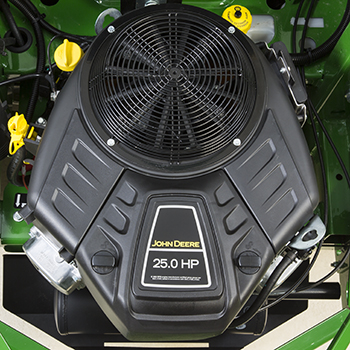 25-hp (18.6-kW) engine
25-hp (18.6-kW) engine
 Engine oil fill and drain tube
Engine oil fill and drain tube
Key engine features:
- 25 hp (18.6 kW) provides plenty of power.
- Large 44.2-cu in. (810-cc) displacement provides excellent torque.
- V-twin cylinder design allows for easy starts, excellent power and performance, and smooth operation.
- Engine model is HTR810.
- Many quality features are included.
- Cast-iron cylinder liners provide a long-wearing surface for longer engine life.
- Overhead valve design allows the engine to breathe easily for excellent power and fuel economy.
- Mechanical compression release provides smooth, easy starts and instant return to maximum power after starting.
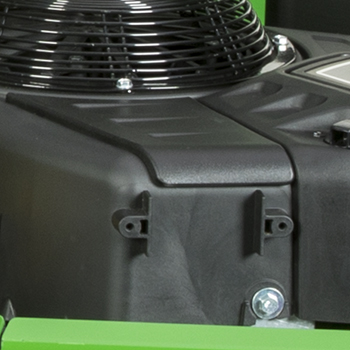 Engine fin inspection/cleanout panel
Engine fin inspection/cleanout panel
 Engine debris chopper fan guard
Engine debris chopper fan guard
- Cooling fin inspection panels allow for checking and cleaning the engine cooling fins
- A debris chopper fan helps keep the engine fins clean by filtering out debris and reducing the size of material that gets through so it will pass harmlessly past the engine fins.
- The air screen cover provides protection from the rotating fan.
 Engine oil check/fill and drain tube
Engine oil check/fill and drain tube
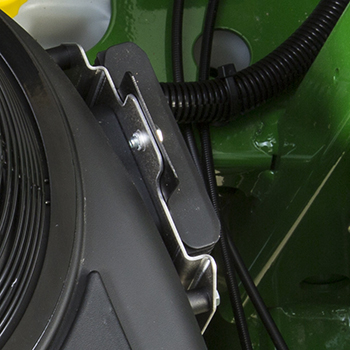 Engine oil cooler
Engine oil cooler
- Full-pressure lubrication system provides plenty of oil to the engines moving parts to ensure reliable operation and long life:
- Replaceable oil filter keeps the oil cleaner for a longer engine life and extends the time between oil changes
- No-tools oil drain is convenient to use.
- A flexible drain tube can be placed above a drain pan to eliminate oil spills.
- Engine oil cooler reduces oil temperature, improves lubrication, and extends oil change intervals.
 Engine air filter panel
Engine air filter panel
 Air filter cover removed
Air filter cover removed
- A 5-in. (12.7-cm) centrifugal multi-stage air cleaner provides maximum engine protection, especially under dirty and dusty conditions.
- Electronic ignition contributes to fast starts.
- Solenoid-shift starter allows for easy starts, even in cold weather.
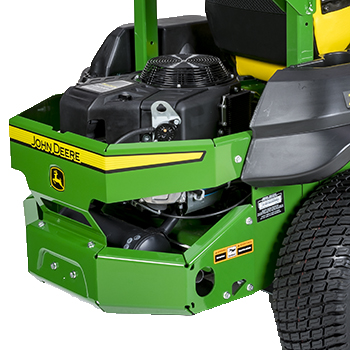 Rear engine guard
Rear engine guard
- A rear engine guard protects the engine and provides additional vehicle strength and integrity.
- A flywheel alternator provides plenty of capacity to quickly recharge the battery and power electrical equipment, such as lights or a sprayer.
- 20-amp capacity
- Regulated to keep the battery at a full charge without risk of overcharging
John Deere recommends the use of fuel stabilizer in gasoline. See Fuel-Protect for gasoline engines (8 oz [237 mL]) for more information.
8-gal. (30.3-L) fuel capacity for extended mowing times
 Easy-to-see fuel sight gauge
Easy-to-see fuel sight gauge
 Large fuel-fill opening and angled fuel filler neck
Large fuel-fill opening and angled fuel filler neck
The large-capacity fuel tank is easy to fill, and a convenient fuel level gauge is provided:
- Holds 8-gal. (30.3-L) of fuel to reduce time needed for refills
- Easy to see how much fuel is in the tank by viewing the sight gauge when approaching from the front of the machine
- Large, 3.5-in. (8.9-cm) fuel fill diameter for easy filling and minimum chance of spills
- Fuel fill location low for easy filling, within easy reach of the operator
John Deere recommends the use of fuel stabilizer in gasoline. See Fuel-Protect for gasoline engines (8 oz [237 mL]) for more information.
Transmission offers speeds up to 9.5 mph (15.3 km/h) to maximize mowing efficiency
 Dual Hydro-Gear® transmissions (Z740R shown)
Dual Hydro-Gear® transmissions (Z740R shown)
Dual transmissions efficiently power the ZTrak™ mower forward and reverse and give steering capability:
- The unitized hydrostatic drive features a hydraulic pump combined with a commercial-grade, heavy-duty wheel motor into a single unit.
- One pump and one motor transmission to drive each wheel provides several benefits:
- Exceptional cooling in high-load conditions
- Easy-to-check fluid level and refill with hydraulic oil
- Opens up access under the seat
- Transmissions are set low in the vehicle for excellent hillside stability.
- Heavy-duty components stand up to the higher loads from the larger tires and greater weight of Z700 Series ZTrak Mowers.
- Low maintenance, unitized transmissions are sealed and have no hose connections to leak hydraulic fluid.
- Four-bolt hubs provide a reliable and convenient wheel-mounting system.
The hydrostatic drive features two Hydro-Gear ZT-3200™ transmissions for superior performance and durability:
- Unitized hydraulic pumps and commercial-grade, heavy-duty wheel motors combined into a single unit
- Speeds up to 9.5 mph (15.3 km/h)
- Pump displacement: 0.61 cu in. (10 cc) per revolution
- Motor displacement: 0.97 cu in. (16 cc) per revolution
- Durable 1.125-in. (2.86-cm) axles for heavy loads
- Standard shock valves for added system protection
- Standard charge pump for increased performance
- External oil filter for easier maintenance
Expansion tanks and tow valve controls
 Transmission expansion tank and filler cap
Transmission expansion tank and filler cap
 Tow-valve control, right
Tow-valve control, right
Transmission fluid expansion tanks are provided for each transmission. The yellow filler cap is easy to find and identify.
Tow-valve controls are provided for each transmission:
- Controls are located on the transmissions near the expansion tanks where they are easy to reach and use.
- Tow valves allow moving the machine in its neutral position when the engine is not running.
- Simply pull up on the rods and secure them into the slot. When finished moving the machine, return the rods to the operating position.
Hydro-Gear and ZT-3200 are trademarks of Hydro-Gear Limited Partnership AF Holding Company, a Delaware Corporation and Danfoss Power Solutions (US) Company, a Delaware Corporation
Operator station is adjustable for superior comfort
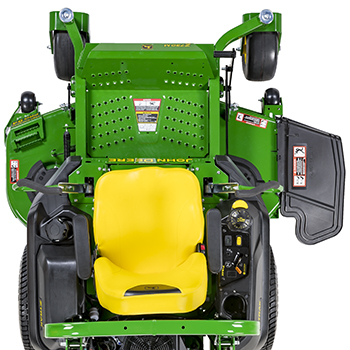 Operator station
Operator station
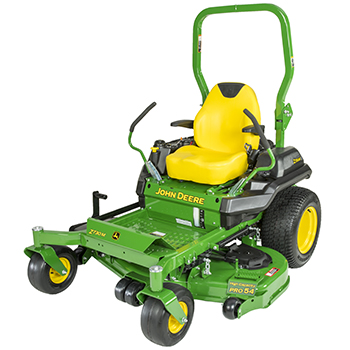 Fully-adjustable operator area
Fully-adjustable operator area
The operator station is designed to provide superior comfort for the operator:
- Adjustable foot platform
- Ample legroom for comfortable operation
- Adjustable seat position, armrests, and suspension to suit the operator
- Can be dialed–in for operator height and weight
- Adjustable motion-control levers
- Upper and lower positioning combined with forward and rearward tilt offers 18 positions
- Large, padded areas on the control levers allow a choice of operator hand positions
- Upper and lower positioning combined with forward and rearward tilt offers 18 positions
Adjustable foot platform
 Adjustable foot platform
Adjustable foot platform
 Large foot platform
Large foot platform
The patent-pending, adjustable three-position toe board allows any operator to quickly adjust the footrest position for greatest comfort.
- Easily and without tools, each operator can adjust the location of the footrest area to the most suitable position.
- Adjustment range of 2 in. (5.1 cm)
- Large operator platform allows a wide range of foot positions.
Adjustable seat
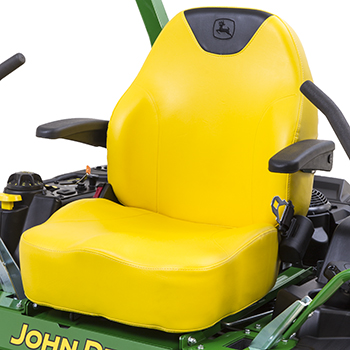 Seat with armrests
Seat with armrests
 ComfortGlide™ suspension control lever
ComfortGlide™ suspension control lever
A deluxe comfort seat with ComfortGlide suspension, fore-aft seat adjustment, and two adjustable suspension springs offers superior ride comfort:
- High-back, 22.5-in. (57.1-cm) seat with adjustable armrests and 3-in. (7.6-cm) fore-aft adjustment
The ComfortGlide suspension is an additional system that generates a controlled fore and aft movement of the seat when experiencing undulations in uneven terrain:
- It dramatically reduces horizontal vibrations, prevents jarring, and makes a big improvement to operator ride comfort.
- The feel of the ride is as if the operator is floating over the ground.
- It allows front-to-rear movement, up to 1-in. (2.5-cm) forward and 1-in. (2.5-cm) rearward, to be absorbed.
- One seat control lever has three positions.
- Slide seat fore/aft up to 3 in. (7.6 cm)
- Engages fore/aft isolator function to allow movement of up to 1 in. (2.5 cm)
- Disengages fore/aft isolator function to lock seat in position
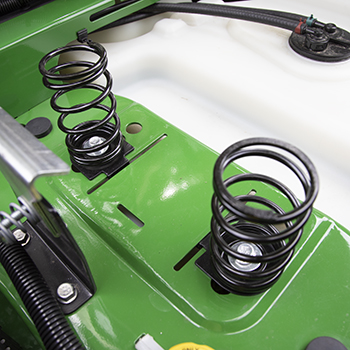 Seat springs in rearward position for heavier operators
Seat springs in rearward position for heavier operators
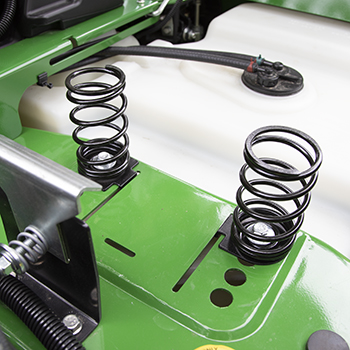 Seat springs in forward position for lighter operators
Seat springs in forward position for lighter operators
Two steel springs under the seat absorb shocks when traveling over rougher areas to provide a smoother ride:
- Fore/aft spring positions – rearward for heavier operators who need more support and forward for lighter operators
- 4-in. (10.2-cm) long steel springs have plenty of travel to give a smooth ride
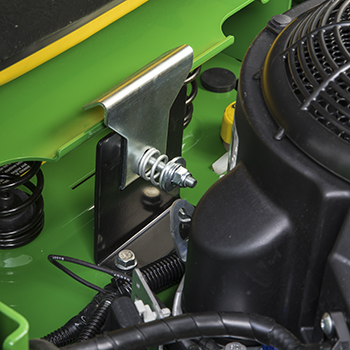 Spring-loaded seat latch
Spring-loaded seat latch
The seat is securely held down, but is easy to raise when necessary:
- A spring-loaded latch locks seat down when it is lowered.
- The seat is easy to release and raise to access adjustable seat springs on E Series and M Series Mowers.
Additional information about the seat is available at: High-quality seat with adjustable springs and armrests for extra comfort
Adjustable steering levers
 Z730M shown mowing
Z730M shown mowing
 Steering levers shown in operating position
Steering levers shown in operating position
Adjustable steering levers are shaped for operator comfort and ease of controlling vehicle speed and direction:
- The premium steering levers on M and R Series machines are painted green and have different bends for more hand positions.
 Steering lever adjustments, low position
Steering lever adjustments, low position
 Steering lever adjustments, high position
Steering lever adjustments, high position
- The levers offer 18 different positions for height and position to accommodate operator preference for hand placement and leg clearance.
Cup holder and storage compartment
 Deluxe cup holder with provision for cup handle
Deluxe cup holder with provision for cup handle
 Protected storage shown with battery cover removed
Protected storage shown with battery cover removed
Operator convenience is provided with easy-to-reach and easy-to-use deluxe cup holder and storage areas:
- Cup holder includes room for a cup with a large handle.
- Covered storage under the battery access panel provides protection for important items.
Seat includes ComfortGlide™ suspension and adjustable springs for a smooth ride
 Seat with armrests
Seat with armrests
 ComfortGlide seat control lever
ComfortGlide seat control lever
The ComfortGlide seat suspension comes with two adjustable springs and no-tools, fore-aft seat adjustment that can be used by the operator while seated:
- High-back, 22.5-in. (57.1-cm) seat with adjustable armrests and 3-in. (7.6-cm) fore-aft adjustment
- The ComfortGlide seat suspension is an additional system that allows a controlled fore and aft movement of the seat when experiencing undulations in uneven terrain.
- Dramatically reduces horizontal vibrations and reduces jarring
- Feel of ride is as if the operator is floating over the ground
- Makes a big improvement to operator ride comfort
- Allows front to rear movement, 1-in. (2.5-cm) forward and 1-in. (2.5-cm) rearward, to be absorbed
- One lever with three positions
- Slide seat fore/aft up to 3 in. (7.6 cm)
- Engage isolator function to allow movement up to 1 in. (2.5 cm) fore and aft
- Disengage isolator function to lock seat in position
 Armrest in raised position
Armrest in raised position
 Armrest height adjustment
Armrest height adjustment
Armrests can be raised for easier entry and exit from the machine.
Infinite height adjustment of the armrest can be made by an easy-to-use thumbscrew.
 Seat springs in rearward position for heavier operators
Seat springs in rearward position for heavier operators
 Seat springs in forward position for lighter operators
Seat springs in forward position for lighter operators
Two steel springs under the seat absorb shocks when traveling over rougher areas to provide a smoother ride.
- Fore/aft spring positions – rearward may be suitable for heavier operators and forward for lighter operators
- 4-in. (10.2-cm) long springs have plenty of travel to give a smooth ride
 Spring-loaded seat latch
Spring-loaded seat latch
The seat is securely held down, but is easy to raise when necessary:
- A spring-loaded latch locks seat down when it is lowered.
- The seat is easy to release and raise to access adjustable seat springs.
Controls, including an automatic motion-control lever/parking brake system, are easy to find and use
Control panel
 Control panel, Z720E, Z735E, Z730M, Z735M
Control panel, Z720E, Z735E, Z730M, Z735M
The operator control panel is conveniently located to the right of the operator for easy use.
The following controls are found on the right-hand console:
- Key switch
- Hour meter
- Ignition switch
- Power take-off (PTO) control
- Engine speed control
- Engine choke control
- Mower cut-height dial
- Mower transport position lock
- Space for optional light kit switch
Adjustable steering levers
 Motion-control levers in operating position
Motion-control levers in operating position
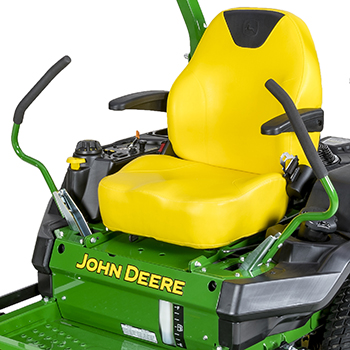 Motion-control levers in park position
Motion-control levers in park position
Motion control levers are shaped and located for operator comfort and ease of control.
Premium control levers on the Z730M, Z735M, and Z740R have a unique shape and size for more comfortable operation.
 18-position control lever adjustment, low
18-position control lever adjustment, low
 18-position control lever adjustment, high
18-position control lever adjustment, high
The motion-control levers can be adjusted to two different height settings and nine different fore-aft settings:
- Combined height and fore/aft positions gives 18 adjustments
- Increased operator comfort with more leg room and more hand positions
- Adjustable for most precise control of the machine
Tracking adjustment
On-board tracking adjustment can be made by the operator from the operator seat.
- A 13-mm socket wrench is required.
Parking brake integrated with motion-control levers for extra convenience
 Motion control levers in, parking brake in disengaged position
Motion control levers in, parking brake in disengaged position
 Motion control levers out, parking brake in engaged position
Motion control levers out, parking brake in engaged position
A patent-pending automatic parking brake system is designed into the steering control levers:
- The mechanical parking brake is operated by the steering control levers.
- The parking brake is engaged when the steering control levers are moved outward, and it is disengaged when the steering control levers are moved inward to the operating position.
- An audible click lets the operator know the brake has fully engaged or disengaged.
The internal parking brake rotor and puck are continually lubricated and cooled for dependable operation and long life.
Mower deck lift/cut-height adjustment
 Mower deck lift pedal
Mower deck lift pedal
 Mower lift-assist spring
Mower lift-assist spring
Mower deck cutting height adjusts from 1.5 in. (3.8 cm) to 5 in. (12.7 cm) in 0.25-in. (0.64-cm) increments for excellent cut quality and performance:
- The foot-lift pedal is used to raise the mower deck for setting cut height or locking in the raised or transport position.
- A lift-assist spring is provided to optimize the effort it takes to raise the mower deck.
 Mower deck cut-height adjustment dial
Mower deck cut-height adjustment dial
 Mower deck transport lock
Mower deck transport lock
- To adjust cut height, simply push down on the foot-lift pedal, adjust the dial, and release the foot-lift pedal to lower the deck to the chosen height.
- Use the foot-lift pedal to lock the deck in transport mode. Simply depress the pedal all the way and the deck will lock into transport mode.
- To unlock and lower the deck, push down on the foot-lift pedal, pull up on the transport unlock lever and release the foot-lift pedal to lower the deck to the chosen height.
Safety interlock system
 Interlock switch is located under the seat
Interlock switch is located under the seat
 Operator presence system seat switch
Operator presence system seat switch
Safety interlocks help prevent operating in an unsafe way:
- The parking brake must be engaged for the engine to crank.
- Parking brake is set when motion-control levers are in the outward position.
- The operator presence system requires the operator to be in the seat to operate the PTO.
- The key switch interlock prevents bypass starting.
- If the operator leaves the seat when the PTO is engaged, controls are in the operating position, or the parking brake is not set, the engine will shut down.
- The seat interlock switch disengages the mower when the operator leaves the seat.
- The engine will stall if the operator leaves the seat without the motion-control levers in the outward position and the parking brake set.
Serviceability is designed-in for convenience
4-year bumper-to-bumper warranty*
Exclusive, 4-year, single-source, bumper-to-bumper warranty is included for all John Deere Z700 Series ZTrak mowers. The warranty places John Deere at the forefront of the mowing industry. It is hassle free, with one company handling all of the paperwork.
Z720E, Z735E |
4-year, 500-hour warranty |
Z730M, Z735M |
4-year, 750-hour warranty |
Z740R |
4-year, 1000-hour warranty |
Service interval decal
 Daily service decal
Daily service decal
A convenient service decal gives basic maintenance information. It provides a quick reference for keeping recommended service up to date. It is located underneath the battery cover.
Flip-up foot platform for mower deck access
 Operator foot platform
Operator foot platform
 Easy-to-remove foot platform (Z720E shown)
Easy-to-remove foot platform (Z720E shown)
The professional-style steel foot platform is easy to remove without tools:
- Makes cleaning grass off the top of the mower deck easier
- Provides convenient access to the mower deck for service
Engine service
 Engine oil check/fill and drain tube (Z720E, Z730M, Z740R)
Engine oil check/fill and drain tube (Z720E, Z730M, Z740R)
 Engine oil check/fill and drain tube (Z735E, Z735M)
Engine oil check/fill and drain tube (Z735E, Z735M)
The engines are easy to service, including changing the oil and the oil filter and servicing the air filter:
- The engine oil check/fill tube is located at the top of the engine and easy to see and reach.
- No-tools oil drain is convenient to use. A flexible oil drain tube is included to conveniently drain oil into a pan, thus eliminating oil spills.
 Engine air filter panel (Z735E engine shown)
Engine air filter panel (Z735E engine shown)
 Air filter cover removed (Z735E shown)
Air filter cover removed (Z735E shown)
 Multi-stage canister air filter system (Z740R shown)
Multi-stage canister air filter system (Z740R shown)
 Air filter element (Z740R shown)
Air filter element (Z740R shown)
Engine air filters are at the top of the engine for easy service:
- Z720E, Z735E, Z730M, and Z735M engines have knobs to remove the filer cover.
- The Z740R has a heavy-duty, multi-stage canister air filter system, which uses a round primary and secondary filter that are easily accessed with latches on the end cap.
Grease fittings
 Top of the mower deck
Top of the mower deck
Only three grease fittings require service:
Three to lubricate the mower-blade spindles, two easily accessed from the spindle covers, and the third by removing the foot platform.
Battery accessibility
 Battery cover
Battery cover
 340 CCA battery
340 CCA battery
The battery is protected from debris, dust, and moisture:
- It is easy to access under the panel on the left-hand side of the machine.
- Held in place by an easy-to-remove thumbscrew
- Powerful 340 cold cranking amp (CCA) battery provides dependable starts.
 Easy-to-clean flat-top mower deck
Easy-to-clean flat-top mower deck
 Flip-up spindle cover for easy cleanout and maintenance
Flip-up spindle cover for easy cleanout and maintenance
Serviceability is designed into the mower deck:
- Easy access is provided by the removable operator foot platform.
- Flat-top design minimizes places for debris to collect.
- Spring-loaded, flip-up belt guards make removing debris easy.
- A provision is provided for a standard, 3/8-in. (9.5-mm) ratchet wrench to be used for releasing belt tension when removing the drive belt.
Mower deck serviceability
 Floating deck mounting system
Floating deck mounting system
 Deck-level adjustment
Deck-level adjustment
A patent-pending deck-leveling system provides easy adjustment at all four mower mounting points:
- Loosen the nut (B) slightly with a 15-mm wrench.
- Using the open end of a 16-mm wrench on the hex fastener (A), raise or lower the deck as needed so the height of the rear blade tip is 3 to 6 mm (1/8 to 1/4 in.) higher than the front blade tip.
- Tick marks on bracket (C) are provided to aid in observing movement.
- When the deck is at the height needed, tighten the nut (B).
Transmission bypass (tow valves)
 Tow-valve control, right (knob pictured in neutral position)
Tow-valve control, right (knob pictured in neutral position)
Tow-valve controls are provided for each transmission:
- Controls are located at the rear of the machine and are easy to access.
- Tow valves allow moving the machine in its neutral position when the engine is not running.
- Simply, loosen the knob, push towards the front of the machine, and tighten the knob back. When finished moving the machine, return the rods to the operating position.
Built-in tie-down locations
 Built-in front tie-down location, right side
Built-in front tie-down location, right side
 Built-in front tie-down location, left side
Built-in front tie-down location, left side
 Built-in rear tie-down location, right side
Built-in rear tie-down location, right side
 Built-in rear tie-down location, left side
Built-in rear tie-down location, left side
Four tie-down locations are provided for convenience and safety when trailering the machine.
Operator digital video disc (DVD)
An operation and safety DVD is provided with each machine. Please consult the operator’s manual for other safety and operating procedures.
*Term limited to years or hours used, whichever comes first, and varies by model. See the LIMITED WARRANTY FOR NEW JOHN DEERE TURF AND UTILITY EQUIPMENT at JohnDeere.com or JohnDeere.ca/TUWarranty for details.
High-capacity (HC) PRO Mower Decks offer superior cut quality and versatility
 Z720E with 54-in. (137-cm) HC PRO Mower Deck
Z720E with 54-in. (137-cm) HC PRO Mower Deck
 Z735M with 60-in. (152-cm) HC PRO Mower Deck
Z735M with 60-in. (152-cm) HC PRO Mower Deck
Each Z700 Series ZTrak™ Mower is equipped with either a 48-in. (122-cm), 54-in. (137-cm), or 60-in. (152-cm) HC PRO Mower Deck.
Mower/vehicle compatibility
| High-capacity (HC) mower deck | ZTrak model | |||||
| Z720E | Z735E | Z730M | Z735M | Z740R | Z740R with Tweel® tire technology | |
| 48-in. (122-cm) High-capacity PRO | X | X | X | |||
| 54-in. (137-cm) High-capacity PRO | X | X | X | X | X* | |
| 60-in. (152-cm) High-capacity PRO | X | X | X | X | X | X* |
*Not compatible with material collection system (MCS)
Deep deck design
 Deep, flat-top deck
Deep, flat-top deck
 Deep-deck mower design
Deep-deck mower design
The mower deck has a deep-deck design:
- Constructed from heavy, 9-gauge, 0.15-in. (3.8-mm) steel.
- Minimizes the number of welds required
- Has a smooth underside for reduced material buildup
- Deep-deck design delivers excellent airflow, so large volumes of material can be processed quickly and efficiently.
- A wider and higher discharge opening provides even clipping dispersal for an excellent finished appearance in all conditions.
- A durable plastic deflector spreads grass clippings evenly across the lawn, is hinged, and can be raised to minimize the storage space required.
- 1-in. (25.4-mm) cold-forged spindles are heat-treated for strength and are supported by ball bearings.
- Standard front rollers and two double-captured wheels provide a more even mowing job and reduce the chance of scalping.
- Adjustable for different mowing heights
- The front edge is raised above the blade plane to allow for even cutting of tall grass.
- Blade overlap is greater than many conventional decks for a clean cut.
- The mower can side-discharge, mulch, or collect material, except a Z740R equipped with Tweel tires is not compatible with a material collection system.
 Mower level adjustment
Mower level adjustment
- Deck leveling and rake angle adjustment is provided at all four mower mounting points.
Step weldment
 Operator step welded on mower deck
Operator step welded on mower deck
A permanent step weldment is located at the left front corner of the mower deck:
- Encourages proper entry to the operator station
- Provides a good gripping surface for the operator’s foot
Reinforced leading edge
 Reinforced leading edge of mower deck
Reinforced leading edge of mower deck
 Trim side of mower reinforcement/wear bar
Trim side of mower reinforcement/wear bar
Steel reinforcing bars are welded to the front edge and trim side of the mower deck:
- Strengthens the deck to reduce chance of damage from obstructions
- Increased material thickness for longer life of the deck
Superior durability is designed in
 Deep mower deck spindle pocket
Deep mower deck spindle pocket
 Flip-up spindle cover
Flip-up spindle cover
The deck has deep, strong spindle pockets to keep the blades aligned, even after years of tough operation:
- Ribs formed in the deck shell add strength where it is needed.
- The aluminum spindle housing has 8-in. (20-cm) base for extra strength.
Flip-up spindle covers make cleaning the spindle area convenient.
Wheels and rollers
 Right mower anti-scalp wheel and center rollers
Right mower anti-scalp wheel and center rollers
 Left mower anti-scalp wheel
Left mower anti-scalp wheel
Dual-captured front and side anti-scalp wheels:
- Give a more even mowing job and reduce the chance of scalping
- Adjustable for different mowing heights
Optional MulchControl™ attachment
The MulchControl attachment makes mulching more practical for many mowing situations because it not only does an excellent job of mulching but it also allows the mower to be easily converted for times when it is more desirable to side discharge or collect the lawn material.
Advantages of mulching grass clippings include:
- A beautiful looking lawn
- Grass clippings not blown onto the operator, driveways, or flower beds
- Less fertilizer use
- Elimination of the effort needed to dispose of clippings
How MulchControl works
 Illustration of MulchControl baffle open
Illustration of MulchControl baffle open
 Illustration of MulchControl baffle closed
Illustration of MulchControl baffle closed
MulchControl is an innovative, simple design that is easy to use and maintain:
- The MulchControl attachment includes baffles to control the flow of material under the deck.
- The left mower blade area is completely enclosed and optimized for mulching and will mulch even when the mower is in the side-discharge mode.
- Baffles around the center and right blades are optimized for mulching when the discharge baffle is closed.
- The attachment also includes mulching blades.
Optional 6.5-bu (229-L) ZTrak Z700 Series MCS
 6.5-bu (230-L) hopper and included weights (chute, blower and attachment bar sold separately)
6.5-bu (230-L) hopper and included weights (chute, blower and attachment bar sold separately)
 6.5-bu (230-L) rear hopper, chute, attachment bar, and blower
6.5-bu (230-L) rear hopper, chute, attachment bar, and blower
The 6.5-bu (230-L) rear bagger efficiently collects material from a 48-, 54-, or 60-in. (122-, 137-, or 152-cm) Mower Deck:
- Hopper, attachment bar/bumper, Power Flow™ blower, and chute components are ordered separately to make a complete MCS.
- A weight bracket and four 18-lb (8.2-kg) weights are included for installation on the front of the vehicle to help counterbalance the weight of the hopper. For proper ballast with complete MCS:
- Four weights are required on a ZTrak Z700 Series equipped with a 48-in. (122-cm) Mower Deck.
- Three weights are required on a ZTrak Z700 Series equipped with a 54-in. (137-cm) Mower Deck.
- Two weights are required on a ZTrak Z700 Series equipped with a 60-in. (152-cm) Mower Deck.
MulchControl handle is used to control baffle
 MulchControl baffle closed
MulchControl baffle closed
 MulchControl handle in closed position
MulchControl handle in closed position
The MulchControl handle is located on top of the mower deck and used to open and close the discharge baffle:
- The operator is required to get off of the machine in order to engage or disengage mulch mode.
- MulchControl is well suited to the following mowing situations:
- Operators who usually mulch, but side-discharge when grass gets too long
- Operators who usually side discharge, but would like to be able to close the chute to control clippings
- Operators who always mulch a main lawn, but often side discharge secondary lawns
- Operators who bag clippings, but want to go farther before emptying bags
MulchControl puts the operator in control of the clippings. The operator can have all the benefits of mulching with the ability to easily change to side-discharge or bagging when needed.
MulchControl limitations
While in the side-discharge mode, MulchControl will still mulch about one third of the material. Therefore, the side-discharge mode is essentially a partial-mulch mode. This can be an advantage when side discharging or bagging, as it helps to reduce the amount of material being discharged. Other times this could work as a disadvantage:
- When cutting strong southern grasses, such as Zoysia and Bermuda
- When cutting in wet, high-growth conditions, such as those found in the Pacific Northwest United States
- When optimum bagging and lawn clean-up is desired
Compatibility
MulchControl is a field-installed attachment and compatible with the 48-in. (122-cm), 54-in. (137-cm), and 60-in. (152-cm) HC PRO Mower Decks available for the Z700 Series ZTrak Mowers.
 Removing bag from 6.5-bu (230-L) hopper
Removing bag from 6.5-bu (230-L) hopper
 Removing bag from 6.5-bu (230-L) hopper
Removing bag from 6.5-bu (230-L) hopper
The hopper design provides efficient bagging performance, clean operation, and easy-to-empty bags:
- Two durable bags give a generous, 6.5-bu (230-L) capacity.
- The bags lift out for easy emptying.
- An efficient chute provides a smooth flow of material to reduce the chance of plugging.
- The chute and Power Flow blower must be ordered separately.
- Standard mower blades are used for bagging.
- The air exhaust duct directs air from the hopper back and toward the ground for clean operation.
- Convenient latch makes opening and closing the hopper easy.
NOTE: Appropriate hopper, Power Flow blower, chute, and attachment bar are required and ordered separately.
Specifications
Capacity |
6.5 bu (230 L) |
Material: |
|
Hopper top |
High impact polypropylene |
Chute |
Polyethylene |
Blower housing |
Nylon |
Fan |
Ultra-high molecular weight (UHMW) polyethylene |
Bags |
Polyester |
Filling |
Directly into bags for emptying on ground or in trailer or into plastic liners |
Fan diameter |
13 in. (33 cm) |
Fan width |
2.75 in. (7 cm) |
Number of fan blades |
Four |
NOTE: MulchControl attachments and MCS components are not included in base equipment for a Z700 Series ZTrak machine and must be ordered separately.
Tweel is a trademark of Michelin North America, Inc.
Features
Heavy-duty design delivers strength and durability
 ZTrak™ Z720E Mower shown
ZTrak™ Z720E Mower shown
 ZTrak Z720E Mower shown
ZTrak Z720E Mower shown
Formed and welded steel frame
 Solid steel tube front frame
Solid steel tube front frame
 Strong rear frame for support and protection
Strong rear frame for support and protection
A strong, welded steel frame provides solid, reliable support for the machine components and operator:
- Heavy-duty 3- x 2-in. (76.2- x 51-mm) frame tubing for durability
- Rear frame provides solid support and protection for the engine
Large, smooth-riding front caster wheels
 Large caster wheel
Large caster wheel
 Caster wheel spindle housing
Caster wheel spindle housing
Large front caster wheels provide a smooth ride and level cut:
- A large surface area helps to provide a smooth ride for the operator.
- Pneumatic tires for the smoothest ride (Z720E, Z735E, Z730M, Z735M, Z740R)
- Semi-pneumatic tires for extra reliability and durability (Z740R with Tweel® tire technology)
- Better performance on slopes
- Caster wheels turn easily on two maintenance-free sealed ball bearings for both the spindles and the wheel axles.
- Long, trouble-free life
- Designed to give smooth turns without damage to the turf
Large rear drive wheels for a smooth ride and level cut
 23-in. (58.4-cm) diameter rear tire (E and M Series)
23-in. (58.4-cm) diameter rear tire (E and M Series)
 24-in. (61-cm) diameter rear tire (Z740R)
24-in. (61-cm) diameter rear tire (Z740R)
Rear tires have high-quality tread and optimum size for superior traction and smooth ride:
- Tire width is optimized for mower deck size.
- 9.5 in. (24 cm) for 48-in. (122-cm) mowers (E, M, R Series)
- 10.5 in. (26.7 cm) for 54-in. (137-cm) and 60-in. (152-cm) mowers (E, M Series)
- 12 in. (30.5 cm) for 54-in. (137-cm) and 60-in. (152-cm) mowers (Z740R)
- Tread pattern is optimized for excellent traction and minimum turf damage.
- Special wheel design gives an enhanced appearance to the machine.
- Optional Michelin® X® Tweel Turf airless radial tire technology on the Z740R provides extra reliability and ride quality.
Standard two-post foldable Roll-Gard™ rollover protective structure (ROPS) increases operator safety
 Clean, open operator station
Clean, open operator station
 Standard folding ROPS
Standard folding ROPS
The operator station has been designed for comfort, visibility, and ease of use:
- Operator station provides plenty of room for comfortable operation.
- Flat operator station makes getting on and off easy.
- Step weldment on mower deck is convenient for the operator.
- Controls are located close to the operator for convenience.
- Operator controls are color coded for easy identification and operation.
 ROPS folded to mid position
ROPS folded to mid position
 ROPS folded to down position (hitch is base equipment on M and R Series; optional field installed kit on E Series)
ROPS folded to down position (hitch is base equipment on M and R Series; optional field installed kit on E Series)
ZTrak Z700 Series Mowers are equipped with a foldable Roll-Gard rollover protective structure (ROPS) and retractable seat belt:
- They help protect the operator in the event of tip over.
- Easy-fold ROPS improves the ability to store the ZTrak in a garage.
- The ROPS is designed to meet or exceed American Society of Agricultural Engineers (ASAE) safety standards.
- Easy-fold ROPS includes a built-in isolator.
- When the ROPS is up, the overall height is 71.1 in. (182.2 cm) for all models except the Z740R, which is 72.1 in. (183.2 cm).
- When the ROPS is down, the overall height is 47.4 in. (120.3 cm) for E Series, 49.7 in. (126.2 cm) for M Series, and 51 in. (129.5 cm) for R Series.
- To fold, remove the two pins and rotate the top of the Roll-Gard downward.
- The Roll-Gard must be in the upright and locked position when low clearance is not required.
- The ROPS and seat belt are included in base equipment.
- Use of the seat belt is recommended when operating with ROPS in the upright position.
Heavy-duty step weldment
 Step weldment on the mower deck
Step weldment on the mower deck
A heavy-duty, permanent step weldment is located at the left front corner of the mower deck:
- Encourages proper entry to the operator station
- Provides a good gripping surface for the operator’s foot
Michelin, X, and Tweel are trademarks of Michelin North America, Inc.
Three-position, adjustable foot platform to accommodate different size operators
 ZTrak™ Z720E Mower shown
ZTrak™ Z720E Mower shown
 ZTrak Z720E Mower shown
ZTrak Z720E Mower shown
An ergonomic design and professional grade components are suitable for a wide variety of operators and conditions:
- Comfortable operator station and convenient controls help optimize operator experience.
- Large operator platform allows a wide range of foot positions.
Adjustable features customize the mowing experience for each operator. One of these features is an adjustable foot platform.
Operator platform designed for adjustability and comfort
 Operator station
Operator station
 Three-position foot platform for operator comfort, rearward position
Three-position foot platform for operator comfort, rearward position
The patent-pending, adjustable, three-position toe board allows the operator to quickly adjust the footrest position for greatest comfort:
- Easily and without tools, each operator can adjust the location of the footrest area to the optimum position.
- Adjustment range of 2 in. (5.1 cm) in 1-in. (2.5-cm) increments is possible.
 Adjustable foot platform, forward position
Adjustable foot platform, forward position
 Adjustable foot platform, middle position
Adjustable foot platform, middle position
Short operators may be most comfortable with the platform in the rear position (as shown above), while tall operators may be more comfortable with the platform in the forward position. Or perhaps, the middle position provides just the right amount of leg room.
Foot pegs (standard on R Series, optional on E and M Series)
 Foot platform with foot pegs
Foot platform with foot pegs
 Foot peg mounting holes
Foot peg mounting holes
Patent-pending foot pegs (standard on R Series, optional on E and M Series) provide the operator with different foot placement options.
- Foot pegs can be adjusted into two different positions, horizontal or at an angle, to provide more variability for foot placement. The pegs also act as handles to remove and replace the foot platform.
Smooth and powerful V-twin engine for performance and long life
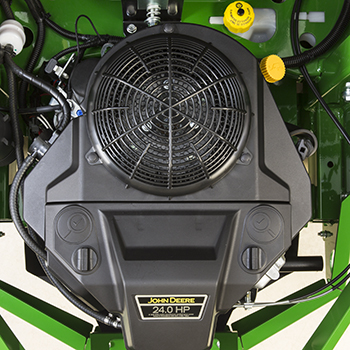 24-hp (17.9-kW) engine
24-hp (17.9-kW) engine
 Z730M engine
Z730M engine
Key engine features:
- 24 hp (17.9 kW) provides plenty of power.
- Large 44.3-cu in. (726-cc) displacement provides excellent torque.
- V-twin, 90-degree cylinder design allows for easy starts, excellent power and performance, and smooth operation.
- Engine model is FS730V.
- Many quality features are included.
- Cast-iron cylinder liners provide a long-wearing surface for longer engine life.
- Overhead V-valves allow the engine to breathe easily for excellent power and fuel economy.
- Automatic compression release provides easy starting.
- Internally vented carburetor maintains proper fuel mixture and minimizes emissions.
- Fuel shutoff solenoid stops excess fuel from entering the exhaust system and causing after bang upon shut down.
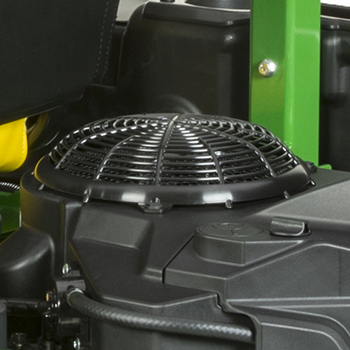 Engine debris chopper fan guard
Engine debris chopper fan guard
- A rotating metal grass chopper screen helps keep the engine fins clean by filtering out debris and reducing the size of material that gets through so it will pass harmlessly past the engine fins.
- The guard provides protection from the rotating fan.
 Engine oil check/fill and drain tube
Engine oil check/fill and drain tube
- Full-pressure lubrication system provides plenty of oil to the engines moving parts to ensure reliable operation and long life:
- No-tools oil drain is convenient to use.
- A flexible drain tube can be placed above a drain pan to eliminate oil spills.
- Replaceable oil filter keeps the oil cleaner for a longer engine life and extends the time between oil changes.
 Air filter/cleanout port cover and removal knobs
Air filter/cleanout port cover and removal knobs
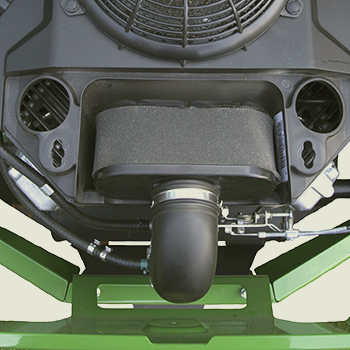 Air filter/cleanout port cover removed
Air filter/cleanout port cover removed
- Integrated cleanout ports allow for checking and cleaning the engine cooling fins.
- Heavy-duty, multi-stage air filter system thoroughly cleans the engine intake air.
- Electronic ignition contributes to fast starts.
 Rear engine guard
Rear engine guard
- A rear engine guard protects the engine and provides additional vehicle strength and integrity.
- A flywheel alternator provides plenty of capacity to quickly recharge the battery and power electrical equipment, such as lights or a sprayer.
- 20-amp capacity
- Regulated to keep the battery at a full charge without risk of overcharging
John Deere recommends the use of fuel stabilizer in gasoline. See Fuel-Protect for gasoline engines (8 oz [237 mL]) for more information.
8-gal. (30.3-L) fuel capacity for extended mowing times
 Easy-to-see fuel sight gauge
Easy-to-see fuel sight gauge
 Large fuel-fill opening and angled fuel filler neck
Large fuel-fill opening and angled fuel filler neck
The large-capacity fuel tank is easy to fill, and a convenient fuel level gauge is provided:
- Holds 8-gal. (30.3-L) of fuel to reduce time needed for refills
- Easy to see how much fuel is in the tank by viewing the sight gauge when approaching from the front of the machine
- Large, 3.5-in. (8.9-cm) fuel fill diameter for easy filling and minimum chance of spills
- Fuel fill location low for easy filling, within easy reach of the operator
John Deere recommends the use of fuel stabilizer in gasoline. See Fuel-Protect for gasoline engines (8 oz [237 mL]) for more information.
Transmission offers speeds up to 9.5 mph (15.3 km/h) to maximize mowing efficiency
 Dual Hydro-Gear® transmissions (Z740R shown)
Dual Hydro-Gear® transmissions (Z740R shown)
Dual transmissions efficiently power the ZTrak™ mower forward and reverse and give steering capability:
- The unitized hydrostatic drive features a hydraulic pump combined with a commercial-grade, heavy-duty wheel motor into a single unit.
- One pump and one motor transmission to drive each wheel provides several benefits:
- Exceptional cooling in high-load conditions
- Easy-to-check fluid level and refill with hydraulic oil
- Opens up access under the seat
- Transmissions are set low in the vehicle for excellent hillside stability.
- Heavy-duty components stand up to the higher loads from the larger tires and greater weight of Z700 Series ZTrak Mowers.
- Low maintenance, unitized transmissions are sealed and have no hose connections to leak hydraulic fluid.
- Four-bolt hubs provide a reliable and convenient wheel-mounting system.
The hydrostatic drive features two Hydro-Gear ZT-3200™ transmissions for superior performance and durability:
- Unitized hydraulic pumps and commercial-grade, heavy-duty wheel motors combined into a single unit
- Speeds up to 9.5 mph (15.3 km/h)
- Pump displacement: 0.61 cu in. (10 cc) per revolution
- Motor displacement: 0.97 cu in. (16 cc) per revolution
- Durable 1.125-in. (2.86-cm) axles for heavy loads
- Standard shock valves for added system protection
- Standard charge pump for increased performance
- External oil filter for easier maintenance
Expansion tanks and tow valve controls
 Transmission expansion tank and filler cap
Transmission expansion tank and filler cap
 Tow-valve control, right
Tow-valve control, right
Transmission fluid expansion tanks are provided for each transmission. The yellow filler cap is easy to find and identify.
Tow-valve controls are provided for each transmission:
- Controls are located on the transmissions near the expansion tanks where they are easy to reach and use.
- Tow valves allow moving the machine in its neutral position when the engine is not running.
- Simply pull up on the rods and secure them into the slot. When finished moving the machine, return the rods to the operating position.
Hydro-Gear and ZT-3200 are trademarks of Hydro-Gear Limited Partnership AF Holding Company, a Delaware Corporation and Danfoss Power Solutions (US) Company, a Delaware Corporation
Operator station is adjustable for superior comfort
 Operator station
Operator station
 Fully-adjustable operator area
Fully-adjustable operator area
The operator station is designed to provide superior comfort for the operator:
- Adjustable foot platform
- Ample legroom for comfortable operation
- Adjustable seat position, armrests, and suspension to suit the operator
- Can be dialed–in for operator height and weight
- Adjustable motion-control levers
- Upper and lower positioning combined with forward and rearward tilt offers 18 positions
- Large, padded areas on the control levers allow a choice of operator hand positions
- Upper and lower positioning combined with forward and rearward tilt offers 18 positions
Adjustable foot platform
 Adjustable foot platform
Adjustable foot platform
 Large foot platform
Large foot platform
The patent-pending, adjustable three-position toe board allows any operator to quickly adjust the footrest position for greatest comfort.
- Easily and without tools, each operator can adjust the location of the footrest area to the most suitable position.
- Adjustment range of 2 in. (5.1 cm)
- Large operator platform allows a wide range of foot positions.
Adjustable seat
 Seat with armrests
Seat with armrests
 ComfortGlide™ suspension control lever
ComfortGlide™ suspension control lever
A deluxe comfort seat with ComfortGlide suspension, fore-aft seat adjustment, and two adjustable suspension springs offers superior ride comfort:
- High-back, 22.5-in. (57.1-cm) seat with adjustable armrests and 3-in. (7.6-cm) fore-aft adjustment
The ComfortGlide suspension is an additional system that generates a controlled fore and aft movement of the seat when experiencing undulations in uneven terrain:
- It dramatically reduces horizontal vibrations, prevents jarring, and makes a big improvement to operator ride comfort.
- The feel of the ride is as if the operator is floating over the ground.
- It allows front-to-rear movement, up to 1-in. (2.5-cm) forward and 1-in. (2.5-cm) rearward, to be absorbed.
- One seat control lever has three positions.
- Slide seat fore/aft up to 3 in. (7.6 cm)
- Engages fore/aft isolator function to allow movement of up to 1 in. (2.5 cm)
- Disengages fore/aft isolator function to lock seat in position
 Seat springs in rearward position for heavier operators
Seat springs in rearward position for heavier operators
 Seat springs in forward position for lighter operators
Seat springs in forward position for lighter operators
Two steel springs under the seat absorb shocks when traveling over rougher areas to provide a smoother ride:
- Fore/aft spring positions – rearward for heavier operators who need more support and forward for lighter operators
- 4-in. (10.2-cm) long steel springs have plenty of travel to give a smooth ride
 Spring-loaded seat latch
Spring-loaded seat latch
The seat is securely held down, but is easy to raise when necessary:
- A spring-loaded latch locks seat down when it is lowered.
- The seat is easy to release and raise to access adjustable seat springs on E Series and M Series Mowers.
Additional information about the seat is available at: High-quality seat with adjustable springs and armrests for extra comfort
Adjustable steering levers
 Z730M shown mowing
Z730M shown mowing
 Steering levers shown in operating position
Steering levers shown in operating position
Adjustable steering levers are shaped for operator comfort and ease of controlling vehicle speed and direction:
- The premium steering levers on M and R Series machines are painted green and have different bends for more hand positions.
 Steering lever adjustments, low position
Steering lever adjustments, low position
 Steering lever adjustments, high position
Steering lever adjustments, high position
- The levers offer 18 different positions for height and position to accommodate operator preference for hand placement and leg clearance.
Cup holder and storage compartment
 Deluxe cup holder with provision for cup handle
Deluxe cup holder with provision for cup handle
 Protected storage shown with battery cover removed
Protected storage shown with battery cover removed
Operator convenience is provided with easy-to-reach and easy-to-use deluxe cup holder and storage areas:
- Cup holder includes room for a cup with a large handle.
- Covered storage under the battery access panel provides protection for important items.
Seat includes ComfortGlide™ suspension and adjustable springs for a smooth ride
 Seat with armrests
Seat with armrests
 ComfortGlide seat control lever
ComfortGlide seat control lever
The ComfortGlide seat suspension comes with two adjustable springs and no-tools, fore-aft seat adjustment that can be used by the operator while seated:
- High-back, 22.5-in. (57.1-cm) seat with adjustable armrests and 3-in. (7.6-cm) fore-aft adjustment
- The ComfortGlide seat suspension is an additional system that allows a controlled fore and aft movement of the seat when experiencing undulations in uneven terrain.
- Dramatically reduces horizontal vibrations and reduces jarring
- Feel of ride is as if the operator is floating over the ground
- Makes a big improvement to operator ride comfort
- Allows front to rear movement, 1-in. (2.5-cm) forward and 1-in. (2.5-cm) rearward, to be absorbed
- One lever with three positions
- Slide seat fore/aft up to 3 in. (7.6 cm)
- Engage isolator function to allow movement up to 1 in. (2.5 cm) fore and aft
- Disengage isolator function to lock seat in position
 Armrest in raised position
Armrest in raised position
 Armrest height adjustment
Armrest height adjustment
Armrests can be raised for easier entry and exit from the machine.
Infinite height adjustment of the armrest can be made by an easy-to-use thumbscrew.
 Seat springs in rearward position for heavier operators
Seat springs in rearward position for heavier operators
 Seat springs in forward position for lighter operators
Seat springs in forward position for lighter operators
Two steel springs under the seat absorb shocks when traveling over rougher areas to provide a smoother ride.
- Fore/aft spring positions – rearward may be suitable for heavier operators and forward for lighter operators
- 4-in. (10.2-cm) long springs have plenty of travel to give a smooth ride
 Spring-loaded seat latch
Spring-loaded seat latch
The seat is securely held down, but is easy to raise when necessary:
- A spring-loaded latch locks seat down when it is lowered.
- The seat is easy to release and raise to access adjustable seat springs.
Controls, including an automatic motion-control lever/parking brake system, are easy to find and use
Control panel
 Control panel, Z720E, Z735E, Z730M, Z735M
Control panel, Z720E, Z735E, Z730M, Z735M
The operator control panel is conveniently located to the right of the operator for easy use.
The following controls are found on the right-hand console:
- Key switch
- Hour meter
- Ignition switch
- Power take-off (PTO) control
- Engine speed control
- Engine choke control
- Mower cut-height dial
- Mower transport position lock
- Space for optional light kit switch
Adjustable steering levers
 Motion-control levers in operating position
Motion-control levers in operating position
 Motion-control levers in park position
Motion-control levers in park position
Motion control levers are shaped and located for operator comfort and ease of control.
Premium control levers on the Z730M, Z735M, and Z740R have a unique shape and size for more comfortable operation.
 18-position control lever adjustment, low
18-position control lever adjustment, low
 18-position control lever adjustment, high
18-position control lever adjustment, high
The motion-control levers can be adjusted to two different height settings and nine different fore-aft settings:
- Combined height and fore/aft positions gives 18 adjustments
- Increased operator comfort with more leg room and more hand positions
- Adjustable for most precise control of the machine
Tracking adjustment
On-board tracking adjustment can be made by the operator from the operator seat.
- A 13-mm socket wrench is required.
Parking brake integrated with motion-control levers for extra convenience
 Motion control levers in, parking brake in disengaged position
Motion control levers in, parking brake in disengaged position
 Motion control levers out, parking brake in engaged position
Motion control levers out, parking brake in engaged position
A patent-pending automatic parking brake system is designed into the steering control levers:
- The mechanical parking brake is operated by the steering control levers.
- The parking brake is engaged when the steering control levers are moved outward, and it is disengaged when the steering control levers are moved inward to the operating position.
- An audible click lets the operator know the brake has fully engaged or disengaged.
The internal parking brake rotor and puck are continually lubricated and cooled for dependable operation and long life.
Mower deck lift/cut-height adjustment
 Mower deck lift pedal
Mower deck lift pedal
 Mower lift-assist spring
Mower lift-assist spring
Mower deck cutting height adjusts from 1.5 in. (3.8 cm) to 5 in. (12.7 cm) in 0.25-in. (0.64-cm) increments for excellent cut quality and performance:
- The foot-lift pedal is used to raise the mower deck for setting cut height or locking in the raised or transport position.
- A lift-assist spring is provided to optimize the effort it takes to raise the mower deck.
 Mower deck cut-height adjustment dial
Mower deck cut-height adjustment dial
 Mower deck transport lock
Mower deck transport lock
- To adjust cut height, simply push down on the foot-lift pedal, adjust the dial, and release the foot-lift pedal to lower the deck to the chosen height.
- Use the foot-lift pedal to lock the deck in transport mode. Simply depress the pedal all the way and the deck will lock into transport mode.
- To unlock and lower the deck, push down on the foot-lift pedal, pull up on the transport unlock lever and release the foot-lift pedal to lower the deck to the chosen height.
Safety interlock system
 Interlock switch is located under the seat
Interlock switch is located under the seat
 Operator presence system seat switch
Operator presence system seat switch
Safety interlocks help prevent operating in an unsafe way:
- The parking brake must be engaged for the engine to crank.
- Parking brake is set when motion-control levers are in the outward position.
- The operator presence system requires the operator to be in the seat to operate the PTO.
- The key switch interlock prevents bypass starting.
- If the operator leaves the seat when the PTO is engaged, controls are in the operating position, or the parking brake is not set, the engine will shut down.
- The seat interlock switch disengages the mower when the operator leaves the seat.
- The engine will stall if the operator leaves the seat without the motion-control levers in the outward position and the parking brake set.
Serviceability is designed-in for convenience
4-year bumper-to-bumper warranty*
Exclusive, 4-year, single-source, bumper-to-bumper warranty is included for all John Deere Z700 Series ZTrak mowers. The warranty places John Deere at the forefront of the mowing industry. It is hassle free, with one company handling all of the paperwork.
Z720E, Z735E |
4-year, 500-hour warranty |
Z730M, Z735M |
4-year, 750-hour warranty |
Z740R |
4-year, 1000-hour warranty |
Service interval decal
 Daily service decal
Daily service decal
A convenient service decal gives basic maintenance information. It provides a quick reference for keeping recommended service up to date. It is located underneath the battery cover.
Flip-up foot platform for mower deck access
 Operator foot platform
Operator foot platform
 Easy-to-remove foot platform (Z720E shown)
Easy-to-remove foot platform (Z720E shown)
The professional-style steel foot platform is easy to remove without tools:
- Makes cleaning grass off the top of the mower deck easier
- Provides convenient access to the mower deck for service
Engine service
 Engine oil check/fill and drain tube (Z720E, Z730M, Z740R)
Engine oil check/fill and drain tube (Z720E, Z730M, Z740R)
 Engine oil check/fill and drain tube (Z735E, Z735M)
Engine oil check/fill and drain tube (Z735E, Z735M)
The engines are easy to service, including changing the oil and the oil filter and servicing the air filter:
- The engine oil check/fill tube is located at the top of the engine and easy to see and reach.
- No-tools oil drain is convenient to use. A flexible oil drain tube is included to conveniently drain oil into a pan, thus eliminating oil spills.
 Engine air filter panel (Z735E engine shown)
Engine air filter panel (Z735E engine shown)
 Air filter cover removed (Z735E shown)
Air filter cover removed (Z735E shown)
 Multi-stage canister air filter system (Z740R shown)
Multi-stage canister air filter system (Z740R shown)
 Air filter element (Z740R shown)
Air filter element (Z740R shown)
Engine air filters are at the top of the engine for easy service:
- Z720E, Z735E, Z730M, and Z735M engines have knobs to remove the filer cover.
- The Z740R has a heavy-duty, multi-stage canister air filter system, which uses a round primary and secondary filter that are easily accessed with latches on the end cap.
Grease fittings
 Top of the mower deck
Top of the mower deck
Only three grease fittings require service:
Three to lubricate the mower-blade spindles, two easily accessed from the spindle covers, and the third by removing the foot platform.
Battery accessibility
 Battery cover
Battery cover
 340 CCA battery
340 CCA battery
The battery is protected from debris, dust, and moisture:
- It is easy to access under the panel on the left-hand side of the machine.
- Held in place by an easy-to-remove thumbscrew
- Powerful 340 cold cranking amp (CCA) battery provides dependable starts.
 Easy-to-clean flat-top mower deck
Easy-to-clean flat-top mower deck
 Flip-up spindle cover for easy cleanout and maintenance
Flip-up spindle cover for easy cleanout and maintenance
Serviceability is designed into the mower deck:
- Easy access is provided by the removable operator foot platform.
- Flat-top design minimizes places for debris to collect.
- Spring-loaded, flip-up belt guards make removing debris easy.
- A provision is provided for a standard, 3/8-in. (9.5-mm) ratchet wrench to be used for releasing belt tension when removing the drive belt.
Mower deck serviceability
 Floating deck mounting system
Floating deck mounting system
 Deck-level adjustment
Deck-level adjustment
A patent-pending deck-leveling system provides easy adjustment at all four mower mounting points:
- Loosen the nut (B) slightly with a 15-mm wrench.
- Using the open end of a 16-mm wrench on the hex fastener (A), raise or lower the deck as needed so the height of the rear blade tip is 3 to 6 mm (1/8 to 1/4 in.) higher than the front blade tip.
- Tick marks on bracket (C) are provided to aid in observing movement.
- When the deck is at the height needed, tighten the nut (B).
Transmission bypass (tow valves)
 Tow-valve control, right (knob pictured in neutral position)
Tow-valve control, right (knob pictured in neutral position)
Tow-valve controls are provided for each transmission:
- Controls are located at the rear of the machine and are easy to access.
- Tow valves allow moving the machine in its neutral position when the engine is not running.
- Simply, loosen the knob, push towards the front of the machine, and tighten the knob back. When finished moving the machine, return the rods to the operating position.
Built-in tie-down locations
 Built-in front tie-down location, right side
Built-in front tie-down location, right side
 Built-in front tie-down location, left side
Built-in front tie-down location, left side
 Built-in rear tie-down location, right side
Built-in rear tie-down location, right side
 Built-in rear tie-down location, left side
Built-in rear tie-down location, left side
Four tie-down locations are provided for convenience and safety when trailering the machine.
Operator digital video disc (DVD)
An operation and safety DVD is provided with each machine. Please consult the operator’s manual for other safety and operating procedures.
*Term limited to years or hours used, whichever comes first, and varies by model. See the LIMITED WARRANTY FOR NEW JOHN DEERE TURF AND UTILITY EQUIPMENT at JohnDeere.com or JohnDeere.ca/TUWarranty for details.
High-capacity (HC) PRO Mower Decks offer superior cut quality and versatility
 Z720E with 54-in. (137-cm) HC PRO Mower Deck
Z720E with 54-in. (137-cm) HC PRO Mower Deck
 Z735M with 60-in. (152-cm) HC PRO Mower Deck
Z735M with 60-in. (152-cm) HC PRO Mower Deck
Each Z700 Series ZTrak™ Mower is equipped with either a 48-in. (122-cm), 54-in. (137-cm), or 60-in. (152-cm) HC PRO Mower Deck.
Mower/vehicle compatibility
| High-capacity (HC) mower deck | ZTrak model | |||||
| Z720E | Z735E | Z730M | Z735M | Z740R | Z740R with Tweel® tire technology | |
| 48-in. (122-cm) High-capacity PRO | X | X | X | |||
| 54-in. (137-cm) High-capacity PRO | X | X | X | X | X* | |
| 60-in. (152-cm) High-capacity PRO | X | X | X | X | X | X* |
*Not compatible with material collection system (MCS)
Deep deck design
 Deep, flat-top deck
Deep, flat-top deck
 Deep-deck mower design
Deep-deck mower design
The mower deck has a deep-deck design:
- Constructed from heavy, 9-gauge, 0.15-in. (3.8-mm) steel.
- Minimizes the number of welds required
- Has a smooth underside for reduced material buildup
- Deep-deck design delivers excellent airflow, so large volumes of material can be processed quickly and efficiently.
- A wider and higher discharge opening provides even clipping dispersal for an excellent finished appearance in all conditions.
- A durable plastic deflector spreads grass clippings evenly across the lawn, is hinged, and can be raised to minimize the storage space required.
- 1-in. (25.4-mm) cold-forged spindles are heat-treated for strength and are supported by ball bearings.
- Standard front rollers and two double-captured wheels provide a more even mowing job and reduce the chance of scalping.
- Adjustable for different mowing heights
- The front edge is raised above the blade plane to allow for even cutting of tall grass.
- Blade overlap is greater than many conventional decks for a clean cut.
- The mower can side-discharge, mulch, or collect material, except a Z740R equipped with Tweel tires is not compatible with a material collection system.
 Mower level adjustment
Mower level adjustment
- Deck leveling and rake angle adjustment is provided at all four mower mounting points.
Step weldment
 Operator step welded on mower deck
Operator step welded on mower deck
A permanent step weldment is located at the left front corner of the mower deck:
- Encourages proper entry to the operator station
- Provides a good gripping surface for the operator’s foot
Reinforced leading edge
 Reinforced leading edge of mower deck
Reinforced leading edge of mower deck
 Trim side of mower reinforcement/wear bar
Trim side of mower reinforcement/wear bar
Steel reinforcing bars are welded to the front edge and trim side of the mower deck:
- Strengthens the deck to reduce chance of damage from obstructions
- Increased material thickness for longer life of the deck
Superior durability is designed in
 Deep mower deck spindle pocket
Deep mower deck spindle pocket
 Flip-up spindle cover
Flip-up spindle cover
The deck has deep, strong spindle pockets to keep the blades aligned, even after years of tough operation:
- Ribs formed in the deck shell add strength where it is needed.
- The aluminum spindle housing has 8-in. (20-cm) base for extra strength.
Flip-up spindle covers make cleaning the spindle area convenient.
Wheels and rollers
 Right mower anti-scalp wheel and center rollers
Right mower anti-scalp wheel and center rollers
 Left mower anti-scalp wheel
Left mower anti-scalp wheel
Dual-captured front and side anti-scalp wheels:
- Give a more even mowing job and reduce the chance of scalping
- Adjustable for different mowing heights
Optional MulchControl™ attachment
The MulchControl attachment makes mulching more practical for many mowing situations because it not only does an excellent job of mulching but it also allows the mower to be easily converted for times when it is more desirable to side discharge or collect the lawn material.
Advantages of mulching grass clippings include:
- A beautiful looking lawn
- Grass clippings not blown onto the operator, driveways, or flower beds
- Less fertilizer use
- Elimination of the effort needed to dispose of clippings
How MulchControl works
 Illustration of MulchControl baffle open
Illustration of MulchControl baffle open
 Illustration of MulchControl baffle closed
Illustration of MulchControl baffle closed
MulchControl is an innovative, simple design that is easy to use and maintain:
- The MulchControl attachment includes baffles to control the flow of material under the deck.
- The left mower blade area is completely enclosed and optimized for mulching and will mulch even when the mower is in the side-discharge mode.
- Baffles around the center and right blades are optimized for mulching when the discharge baffle is closed.
- The attachment also includes mulching blades.
Optional 6.5-bu (229-L) ZTrak Z700 Series MCS
 6.5-bu (230-L) hopper and included weights (chute, blower and attachment bar sold separately)
6.5-bu (230-L) hopper and included weights (chute, blower and attachment bar sold separately)
 6.5-bu (230-L) rear hopper, chute, attachment bar, and blower
6.5-bu (230-L) rear hopper, chute, attachment bar, and blower
The 6.5-bu (230-L) rear bagger efficiently collects material from a 48-, 54-, or 60-in. (122-, 137-, or 152-cm) Mower Deck:
- Hopper, attachment bar/bumper, Power Flow™ blower, and chute components are ordered separately to make a complete MCS.
- A weight bracket and four 18-lb (8.2-kg) weights are included for installation on the front of the vehicle to help counterbalance the weight of the hopper. For proper ballast with complete MCS:
- Four weights are required on a ZTrak Z700 Series equipped with a 48-in. (122-cm) Mower Deck.
- Three weights are required on a ZTrak Z700 Series equipped with a 54-in. (137-cm) Mower Deck.
- Two weights are required on a ZTrak Z700 Series equipped with a 60-in. (152-cm) Mower Deck.
MulchControl handle is used to control baffle
 MulchControl baffle closed
MulchControl baffle closed
 MulchControl handle in closed position
MulchControl handle in closed position
The MulchControl handle is located on top of the mower deck and used to open and close the discharge baffle:
- The operator is required to get off of the machine in order to engage or disengage mulch mode.
- MulchControl is well suited to the following mowing situations:
- Operators who usually mulch, but side-discharge when grass gets too long
- Operators who usually side discharge, but would like to be able to close the chute to control clippings
- Operators who always mulch a main lawn, but often side discharge secondary lawns
- Operators who bag clippings, but want to go farther before emptying bags
MulchControl puts the operator in control of the clippings. The operator can have all the benefits of mulching with the ability to easily change to side-discharge or bagging when needed.
MulchControl limitations
While in the side-discharge mode, MulchControl will still mulch about one third of the material. Therefore, the side-discharge mode is essentially a partial-mulch mode. This can be an advantage when side discharging or bagging, as it helps to reduce the amount of material being discharged. Other times this could work as a disadvantage:
- When cutting strong southern grasses, such as Zoysia and Bermuda
- When cutting in wet, high-growth conditions, such as those found in the Pacific Northwest United States
- When optimum bagging and lawn clean-up is desired
Compatibility
MulchControl is a field-installed attachment and compatible with the 48-in. (122-cm), 54-in. (137-cm), and 60-in. (152-cm) HC PRO Mower Decks available for the Z700 Series ZTrak Mowers.
 Removing bag from 6.5-bu (230-L) hopper
Removing bag from 6.5-bu (230-L) hopper
 Removing bag from 6.5-bu (230-L) hopper
Removing bag from 6.5-bu (230-L) hopper
The hopper design provides efficient bagging performance, clean operation, and easy-to-empty bags:
- Two durable bags give a generous, 6.5-bu (230-L) capacity.
- The bags lift out for easy emptying.
- An efficient chute provides a smooth flow of material to reduce the chance of plugging.
- The chute and Power Flow blower must be ordered separately.
- Standard mower blades are used for bagging.
- The air exhaust duct directs air from the hopper back and toward the ground for clean operation.
- Convenient latch makes opening and closing the hopper easy.
NOTE: Appropriate hopper, Power Flow blower, chute, and attachment bar are required and ordered separately.
Specifications
Capacity |
6.5 bu (230 L) |
Material: |
|
Hopper top |
High impact polypropylene |
Chute |
Polyethylene |
Blower housing |
Nylon |
Fan |
Ultra-high molecular weight (UHMW) polyethylene |
Bags |
Polyester |
Filling |
Directly into bags for emptying on ground or in trailer or into plastic liners |
Fan diameter |
13 in. (33 cm) |
Fan width |
2.75 in. (7 cm) |
Number of fan blades |
Four |
NOTE: MulchControl attachments and MCS components are not included in base equipment for a Z700 Series ZTrak machine and must be ordered separately.
Tweel is a trademark of Michelin North America, Inc.
Features
Heavy-duty design delivers strength and durability
 ZTrak™ Z720E Mower shown
ZTrak™ Z720E Mower shown
 ZTrak Z720E Mower shown
ZTrak Z720E Mower shown
Formed and welded steel frame
 Solid steel tube front frame
Solid steel tube front frame
 Strong rear frame for support and protection
Strong rear frame for support and protection
A strong, welded steel frame provides solid, reliable support for the machine components and operator:
- Heavy-duty 3- x 2-in. (76.2- x 51-mm) frame tubing for durability
- Rear frame provides solid support and protection for the engine
Large, smooth-riding front caster wheels
 Large caster wheel
Large caster wheel
 Caster wheel spindle housing
Caster wheel spindle housing
Large front caster wheels provide a smooth ride and level cut:
- A large surface area helps to provide a smooth ride for the operator.
- Pneumatic tires for the smoothest ride (Z720E, Z735E, Z730M, Z735M, Z740R)
- Semi-pneumatic tires for extra reliability and durability (Z740R with Tweel® tire technology)
- Better performance on slopes
- Caster wheels turn easily on two maintenance-free sealed ball bearings for both the spindles and the wheel axles.
- Long, trouble-free life
- Designed to give smooth turns without damage to the turf
Large rear drive wheels for a smooth ride and level cut
 23-in. (58.4-cm) diameter rear tire (E and M Series)
23-in. (58.4-cm) diameter rear tire (E and M Series)
 24-in. (61-cm) diameter rear tire (Z740R)
24-in. (61-cm) diameter rear tire (Z740R)
Rear tires have high-quality tread and optimum size for superior traction and smooth ride:
- Tire width is optimized for mower deck size.
- 9.5 in. (24 cm) for 48-in. (122-cm) mowers (E, M, R Series)
- 10.5 in. (26.7 cm) for 54-in. (137-cm) and 60-in. (152-cm) mowers (E, M Series)
- 12 in. (30.5 cm) for 54-in. (137-cm) and 60-in. (152-cm) mowers (Z740R)
- Tread pattern is optimized for excellent traction and minimum turf damage.
- Special wheel design gives an enhanced appearance to the machine.
- Optional Michelin® X® Tweel Turf airless radial tire technology on the Z740R provides extra reliability and ride quality.
Standard two-post foldable Roll-Gard™ rollover protective structure (ROPS) increases operator safety
 Clean, open operator station
Clean, open operator station
 Standard folding ROPS
Standard folding ROPS
The operator station has been designed for comfort, visibility, and ease of use:
- Operator station provides plenty of room for comfortable operation.
- Flat operator station makes getting on and off easy.
- Step weldment on mower deck is convenient for the operator.
- Controls are located close to the operator for convenience.
- Operator controls are color coded for easy identification and operation.
 ROPS folded to mid position
ROPS folded to mid position
 ROPS folded to down position (hitch is base equipment on M and R Series; optional field installed kit on E Series)
ROPS folded to down position (hitch is base equipment on M and R Series; optional field installed kit on E Series)
ZTrak Z700 Series Mowers are equipped with a foldable Roll-Gard rollover protective structure (ROPS) and retractable seat belt:
- They help protect the operator in the event of tip over.
- Easy-fold ROPS improves the ability to store the ZTrak in a garage.
- The ROPS is designed to meet or exceed American Society of Agricultural Engineers (ASAE) safety standards.
- Easy-fold ROPS includes a built-in isolator.
- When the ROPS is up, the overall height is 71.1 in. (182.2 cm) for all models except the Z740R, which is 72.1 in. (183.2 cm).
- When the ROPS is down, the overall height is 47.4 in. (120.3 cm) for E Series, 49.7 in. (126.2 cm) for M Series, and 51 in. (129.5 cm) for R Series.
- To fold, remove the two pins and rotate the top of the Roll-Gard downward.
- The Roll-Gard must be in the upright and locked position when low clearance is not required.
- The ROPS and seat belt are included in base equipment.
- Use of the seat belt is recommended when operating with ROPS in the upright position.
Heavy-duty step weldment
 Step weldment on the mower deck
Step weldment on the mower deck
A heavy-duty, permanent step weldment is located at the left front corner of the mower deck:
- Encourages proper entry to the operator station
- Provides a good gripping surface for the operator’s foot
Michelin, X, and Tweel are trademarks of Michelin North America, Inc.
Three-position, adjustable foot platform to accommodate different size operators
 ZTrak™ Z720E Mower shown
ZTrak™ Z720E Mower shown
 ZTrak Z720E Mower shown
ZTrak Z720E Mower shown
An ergonomic design and professional grade components are suitable for a wide variety of operators and conditions:
- Comfortable operator station and convenient controls help optimize operator experience.
- Large operator platform allows a wide range of foot positions.
Adjustable features customize the mowing experience for each operator. One of these features is an adjustable foot platform.
Operator platform designed for adjustability and comfort
 Operator station
Operator station
 Three-position foot platform for operator comfort, rearward position
Three-position foot platform for operator comfort, rearward position
The patent-pending, adjustable, three-position toe board allows the operator to quickly adjust the footrest position for greatest comfort:
- Easily and without tools, each operator can adjust the location of the footrest area to the optimum position.
- Adjustment range of 2 in. (5.1 cm) in 1-in. (2.5-cm) increments is possible.
 Adjustable foot platform, forward position
Adjustable foot platform, forward position
 Adjustable foot platform, middle position
Adjustable foot platform, middle position
Short operators may be most comfortable with the platform in the rear position (as shown above), while tall operators may be more comfortable with the platform in the forward position. Or perhaps, the middle position provides just the right amount of leg room.
Foot pegs (standard on R Series, optional on E and M Series)
 Foot platform with foot pegs
Foot platform with foot pegs
 Foot peg mounting holes
Foot peg mounting holes
Patent-pending foot pegs (standard on R Series, optional on E and M Series) provide the operator with different foot placement options.
- Foot pegs can be adjusted into two different positions, horizontal or at an angle, to provide more variability for foot placement. The pegs also act as handles to remove and replace the foot platform.
Smooth and powerful professional-grade V-twin engine for performance and long life
 25-hp (18.6-kW) engine
25-hp (18.6-kW) engine
 Engine oil fill and drain tube
Engine oil fill and drain tube
Key engine features:
- 25 hp (18.6 kW) provides plenty of power.
- Large 44.2-cu in. (810-cc) displacement provides excellent torque.
- V-twin cylinder design allows for easy starts, excellent power and performance, and smooth operation.
- Engine model is HTR810.
- Many quality features are included.
- Cast-iron cylinder liners provide a long-wearing surface for longer engine life.
- Overhead valve design allows the engine to breathe easily for excellent power and fuel economy.
- Mechanical compression release provides smooth, easy starts and instant return to maximum power after starting.
 Engine fin inspection/cleanout panel
Engine fin inspection/cleanout panel
 Engine debris chopper fan guard
Engine debris chopper fan guard
- Cooling fin inspection panels allow for checking and cleaning the engine cooling fins
- A debris chopper fan helps keep the engine fins clean by filtering out debris and reducing the size of material that gets through so it will pass harmlessly past the engine fins.
- The air screen cover provides protection from the rotating fan.
 Engine oil check/fill and drain tube
Engine oil check/fill and drain tube
 Engine oil cooler
Engine oil cooler
- Full-pressure lubrication system provides plenty of oil to the engines moving parts to ensure reliable operation and long life:
- Replaceable oil filter keeps the oil cleaner for a longer engine life and extends the time between oil changes
- No-tools oil drain is convenient to use.
- A flexible drain tube can be placed above a drain pan to eliminate oil spills.
- Engine oil cooler reduces oil temperature, improves lubrication, and extends oil change intervals.
 Engine air filter panel
Engine air filter panel
 Air filter cover removed
Air filter cover removed
- A 5-in. (12.7-cm) centrifugal multi-stage air cleaner provides maximum engine protection, especially under dirty and dusty conditions.
- Electronic ignition contributes to fast starts.
- Solenoid-shift starter allows for easy starts, even in cold weather.
 Rear engine guard
Rear engine guard
- A rear engine guard protects the engine and provides additional vehicle strength and integrity.
- A flywheel alternator provides plenty of capacity to quickly recharge the battery and power electrical equipment, such as lights or a sprayer.
- 20-amp capacity
- Regulated to keep the battery at a full charge without risk of overcharging
John Deere recommends the use of fuel stabilizer in gasoline. See Fuel-Protect for gasoline engines (8 oz [237 mL]) for more information.
8-gal. (30.3-L) fuel capacity for extended mowing times
 Easy-to-see fuel sight gauge
Easy-to-see fuel sight gauge
 Large fuel-fill opening and angled fuel filler neck
Large fuel-fill opening and angled fuel filler neck
The large-capacity fuel tank is easy to fill, and a convenient fuel level gauge is provided:
- Holds 8-gal. (30.3-L) of fuel to reduce time needed for refills
- Easy to see how much fuel is in the tank by viewing the sight gauge when approaching from the front of the machine
- Large, 3.5-in. (8.9-cm) fuel fill diameter for easy filling and minimum chance of spills
- Fuel fill location low for easy filling, within easy reach of the operator
John Deere recommends the use of fuel stabilizer in gasoline. See Fuel-Protect for gasoline engines (8 oz [237 mL]) for more information.
Transmission offers speeds up to 8 mph (12.8 km/h) to maximize mowing efficiency
 Dual Hydro-Gear® transmissions (Z740R shown)
Dual Hydro-Gear® transmissions (Z740R shown)
Dual transmissions efficiently power the ZTrak™ mower forward and reverse and give steering capability:
- The unitized hydrostatic drive features a hydraulic pump combined with a heavy-duty wheel motor into a single unit.
- One pump and motor transmission to drive each wheel provides several benefits:
- Exceptional cooling in high-load conditions
- Easy-to-check fluid level and refill with hydraulic oil
- Hydraulic oil check/fill accessed by raising the seat
- Transmissions are set low in the vehicle for excellent hillside stability.
- Heavy-duty components stand up to the higher loads from the larger tires and greater weight of Z700 Series ZTrak Mowers.
- Low maintenance, unitized transmissions are sealed and have no hose connections to leak hydraulic fluid.
- Four-bolt hubs provide a reliable and convenient wheel-mounting system.
The hydrostatic drive features two Hydro-Gear ZT-3100® transmissions for superior performance and durability:
- Unitized hydraulic pumps and commercial-grade, heavy-duty wheel motors combined into a single unit
- Speeds up to 8 mph (12.8 km/h)
- Pump displacement: 0.61 cu in. (10 cc) per revolution
- Motor displacement: 0.97 cu in. (16 cc) per revolution
- Durable 1-in. (2.54-cm) axles for heavy loads
- Standard shock valves for added system protection
- Standard charge pump for increased performance
- External oil filter for easier maintenance
Expansion tanks and tow valve controls
 Transmission expansion tank and filler cap
Transmission expansion tank and filler cap
 Tow-valve control, right
Tow-valve control, right
Transmission fluid expansion tanks are provided for each transmission. Yellow filler cap is easy to find and identify.
Tow-valve controls are provided for each transmission:
- Controls are located on the transmissions near the expansion tanks where they are easy to reach and use.
- Tow valves allow moving the machine in its neutral position when the engine is not running.
- Simply, pull up on the rods and secure them into the slot. When finished moving the machine, return the rods to the operating position.
Hydro-Gear and ZT-3100 are trademarks of Hydro-Gear Limited Partnership AF Holding Company, a Delaware Corporation and Danfoss Power Solutions (US) Company, a Delaware Corporation.
Operator station is adjustable for superior comfort
 Operator station
Operator station
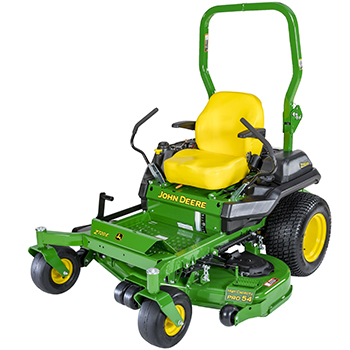 Fully-adjustable operator area
Fully-adjustable operator area
The operator station is designed to provide superior operator comfort for many different operators:
- Adjustable foot platform
- Ample legroom for comfortable operation
- Adjustable seat position, armrests, and suspension to suit many operators
- Dialed in for operator height and weight
- Adjustable motion-control levers
- Upper and lower positioning combined with forward and rearward tilt offers more legroom and hand positions
Adjustable foot platform
 Adjustable foot platform
Adjustable foot platform
 Large foot platform
Large foot platform
The patent-pending, adjustable three-position toe board allows any operator to quickly adjust the footrest position for greatest comfort:
- Easily and without tools, each operator can adjust the location of the footrest area to the most suitable position.
- Adjustment range of 2 in. (5.1 cm)
- Large operator platform allows a wide range of foot positions.
Adjustable seat
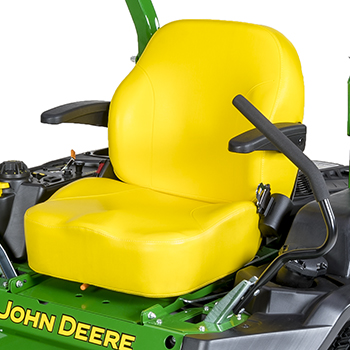 Seat with adjustable armrests
Seat with adjustable armrests
 Fore-aft seat adjustment lever
Fore-aft seat adjustment lever
A deep, padded seat combined with adjustable armrests, adjustable fore/aft position, and adjustable suspension springs optimizes comfort for the operator:
- High-back, 21-in. (53.3-cm) seat comes with adjustable armrests and 4-in. (10.2-cm) fore-aft adjustment.
- Seat-adjustment lever is located at the front edge of the seat for easy use by the operator while seated.
 Seat springs in rearward position
Seat springs in rearward position
 Seat springs in forward position
Seat springs in forward position
Two steel springs under the seat absorb shocks when traveling over rough areas to provide a smoother ride:
- Four seat spring positions adjust for operator weight and preference.
- A rearward position may be more suitable for heavier and taller operators and a more forward position for lighter and shorter operators.
- 4-in. (10.2-cm) long steel springs have plenty of travel to give a smooth ride.
 Spring-loaded seat latch
Spring-loaded seat latch
The seat is securely held down for operator comfort and safety, but is easy to raise when necessary:
- A spring-loaded latch locks seat down when it is lowered.
- The seat is easy to release and raise to access adjustable seat springs.
Additional information about the seat is available at: High-quality seat with adjustable springs and armrests for extra comfort
Adjustable steering levers
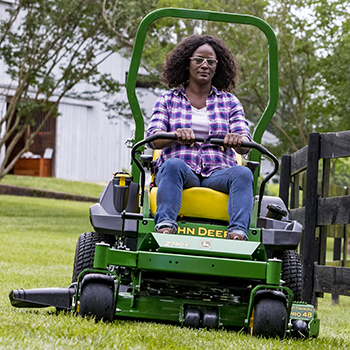 Steering levers in use
Steering levers in use
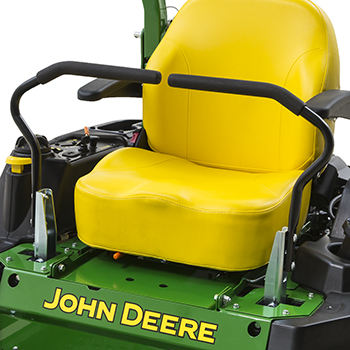 Steering levers, shown in operation position
Steering levers, shown in operation position
Adjustable steering levers are shaped for operator comfort and ease of controlling vehicle speed and direction.
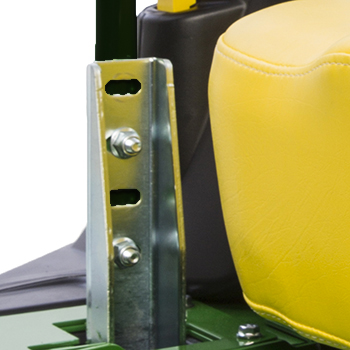 Steering lever height adjustment, low
Steering lever height adjustment, low
 Steering lever height adjustment, high
Steering lever height adjustment, high
The steering levers offer 18 different positions to accommodate operator preference for hand placement and leg clearance.
Cup holder and storage compartment
 Deluxe cup holder with provision for cup handle
Deluxe cup holder with provision for cup handle
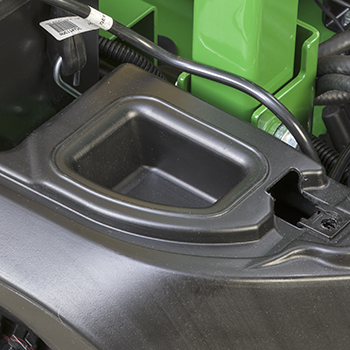 Protected storage shown with battery cover removed
Protected storage shown with battery cover removed
Operator convenience is provided with easy-to-reach deluxe cup holder and storage areas.
- Cup holder includes room for a cup with a large handle.
- Covered storage under the battery access panel provides protection for important items.
High-quality seat with adjustable armrests and springs for extra comfort
 Seat with armrests
Seat with armrests
 Fore-aft seat adjustment lever
Fore-aft seat adjustment lever
A deep padded seat combined with adjustable armrests, adjustable fore/aft position, and adjustable suspension springs optimizes comfort for the operator:
- High-back, 21-in. (53.3-cm) seat with adjustable armrests and 4-in. (10.2-cm) fore-aft adjustment
- Seat-adjustment lever located at the front edge of the seat for easy use by the operator while seated
 Armrest in raised position
Armrest in raised position
 Armrest angle adjustment knob
Armrest angle adjustment knob
Armrests can be raised for easier entry and exit from the machine.
Infinite angle adjustment of the armrest can be made by an easy-to-use thumbscrew.
 Seat springs in rearward position for heavier operators
Seat springs in rearward position for heavier operators
 Seat springs in forward position for lighter operators
Seat springs in forward position for lighter operators
Two steel springs under the seat absorb shocks when traveling over rough areas to provide a smoother ride:
- Four seat-spring positions adjust for operator weight and preference.
- Rearward position may be suitable for heavier and taller operators and the forward position for lighter and shorter operators.
- Long, 4-in. (10.2-cm) springs have plenty of travel to give a smoother ride.
 Spring-loaded seat latch
Spring-loaded seat latch
The seat is securely held down, but easy to raise when necessary:
- A spring-loaded latch locks seat down when it is lowered.
- The seat is easy to release and raise to access adjustable seat springs.
Controls, including an automatic motion-control lever/parking brake system, are easy to find and use
Control panel
 Control panel, Z720E, Z735E
Control panel, Z720E, Z735E
The operator control panel is conveniently located to the right of the operator. The following controls are found on the right-hand console:
- Key switch
- Hour meter
- Ignition switch
- Power take-off (PTO) control
- Engine speed control
- Engine choke control
- Mower cut-height dial
- Mower transport position lock
- Space for the optional light kit switch
Adjustable steering levers
 Steering levers in operating position
Steering levers in operating position
 Steering levers in park position
Steering levers in park position
Motion control levers are shaped and located for operator comfort and ease of control.
 18-position control lever adjustment, low
18-position control lever adjustment, low
 18-position control lever adjustment, high
18-position control lever adjustment, high
The motion-control levers can be adjusted to two different height settings and nine different fore-aft settings:
- Combined height and fore/aft positions gives 18 adjustments
- Increased operator comfort with more leg room and more hand positions
- Adjustable for most precise control of the machine
Tracking adjustment
On-board tracking adjustment can be made by the operator from the operator seat.
- A 13-mm socket wrench is required.
Parking brake integrated with motion-control levers for extra convenience
 Motion control levers in, parking brake in disengaged position
Motion control levers in, parking brake in disengaged position
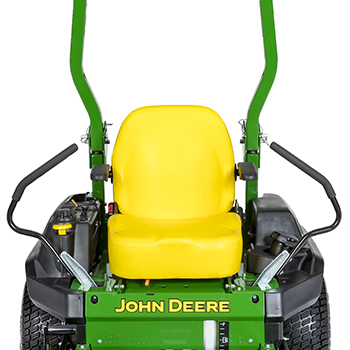 Motion control levers out, parking brake in engaged position
Motion control levers out, parking brake in engaged position
A patent-pending automatic parking brake system is designed into the steering control levers:
- The mechanical parking brake is operated by the steering control levers.
- The parking brake is engaged when the steering control levers are moved outward, and it is disengaged when the steering control levers are moved inward to the operating position.
- An audible click lets the operator know the brake has fully engaged or disengaged.
The internal parking brake rotor and puck are continually lubricated and cooled for dependable operation and long life.
Mower deck lift/cut-height adjustment
 Mower deck lift pedal
Mower deck lift pedal
 Mower lift-assist spring
Mower lift-assist spring
Mower deck cutting height adjusts from 1.5 in. (3.8 cm) to 5 in. (12.7 cm) in 0.25-in. (0.64-cm) increments for excellent cut quality and performance:
- The foot-lift pedal is used to raise the mower deck for setting cut height or locking in the raised or transport position.
- A lift-assist spring is provided to optimize the effort it takes to raise the mower deck.
 Mower deck cut-height adjustment dial
Mower deck cut-height adjustment dial
 Mower deck transport lock
Mower deck transport lock
- To adjust cut height, simply push down on the foot-lift pedal, adjust the dial, and release the foot-lift pedal to lower the deck to the chosen height.
- Use the foot-lift pedal to lock the deck in transport mode. Simply depress the pedal all the way and the deck will lock into transport mode.
- To unlock and lower the deck, push down on the foot-lift pedal, pull up on the transport unlock lever and release the foot-lift pedal to lower the deck to the chosen height.
Safety interlock system
 Interlock switch is located under the seat
Interlock switch is located under the seat
 Operator presence system seat switch
Operator presence system seat switch
Safety interlocks help prevent operating in an unsafe way:
- The parking brake must be engaged for the engine to crank.
- Parking brake is set when motion-control levers are in the outward position.
- The operator presence system requires the operator to be in the seat to operate the PTO.
- The key switch interlock prevents bypass starting.
- If the operator leaves the seat when the PTO is engaged, controls are in the operating position, or the parking brake is not set, the engine will shut down.
- The seat interlock switch disengages the mower when the operator leaves the seat.
- The engine will stall if the operator leaves the seat without the motion-control levers in the outward position and the parking brake set.
Serviceability is designed-in for convenience
4-year bumper-to-bumper warranty*
Exclusive, 4-year, single-source, bumper-to-bumper warranty is included for all John Deere Z700 Series ZTrak mowers. The warranty places John Deere at the forefront of the mowing industry. It is hassle free, with one company handling all of the paperwork.
Z720E, Z735E |
4-year, 500-hour warranty |
Z730M, Z735M |
4-year, 750-hour warranty |
Z740R |
4-year, 1000-hour warranty |
Service interval decal
 Daily service decal
Daily service decal
A convenient service decal gives basic maintenance information. It provides a quick reference for keeping recommended service up to date. It is located underneath the battery cover.
Flip-up foot platform for mower deck access
 Operator foot platform
Operator foot platform
 Easy-to-remove foot platform (Z720E shown)
Easy-to-remove foot platform (Z720E shown)
The professional-style steel foot platform is easy to remove without tools:
- Makes cleaning grass off the top of the mower deck easier
- Provides convenient access to the mower deck for service
Engine service
 Engine oil check/fill and drain tube (Z720E, Z730M, Z740R)
Engine oil check/fill and drain tube (Z720E, Z730M, Z740R)
 Engine oil check/fill and drain tube (Z735E, Z735M)
Engine oil check/fill and drain tube (Z735E, Z735M)
The engines are easy to service, including changing the oil and the oil filter and servicing the air filter:
- The engine oil check/fill tube is located at the top of the engine and easy to see and reach.
- No-tools oil drain is convenient to use. A flexible oil drain tube is included to conveniently drain oil into a pan, thus eliminating oil spills.
 Engine air filter panel (Z735E engine shown)
Engine air filter panel (Z735E engine shown)
 Air filter cover removed (Z735E shown)
Air filter cover removed (Z735E shown)
 Multi-stage canister air filter system (Z740R shown)
Multi-stage canister air filter system (Z740R shown)
 Air filter element (Z740R shown)
Air filter element (Z740R shown)
Engine air filters are at the top of the engine for easy service:
- Z720E, Z735E, Z730M, and Z735M engines have knobs to remove the filer cover.
- The Z740R has a heavy-duty, multi-stage canister air filter system, which uses a round primary and secondary filter that are easily accessed with latches on the end cap.
Grease fittings
 Top of the mower deck
Top of the mower deck
Only three grease fittings require service:
Three to lubricate the mower-blade spindles, two easily accessed from the spindle covers, and the third by removing the foot platform.
Battery accessibility
 Battery cover
Battery cover
 340 CCA battery
340 CCA battery
The battery is protected from debris, dust, and moisture:
- It is easy to access under the panel on the left-hand side of the machine.
- Held in place by an easy-to-remove thumbscrew
- Powerful 340 cold cranking amp (CCA) battery provides dependable starts.
 Easy-to-clean flat-top mower deck
Easy-to-clean flat-top mower deck
 Flip-up spindle cover for easy cleanout and maintenance
Flip-up spindle cover for easy cleanout and maintenance
Serviceability is designed into the mower deck:
- Easy access is provided by the removable operator foot platform.
- Flat-top design minimizes places for debris to collect.
- Spring-loaded, flip-up belt guards make removing debris easy.
- A provision is provided for a standard, 3/8-in. (9.5-mm) ratchet wrench to be used for releasing belt tension when removing the drive belt.
Mower deck serviceability
 Floating deck mounting system
Floating deck mounting system
 Deck-level adjustment
Deck-level adjustment
A patent-pending deck-leveling system provides easy adjustment at all four mower mounting points:
- Loosen the nut (B) slightly with a 15-mm wrench.
- Using the open end of a 16-mm wrench on the hex fastener (A), raise or lower the deck as needed so the height of the rear blade tip is 3 to 6 mm (1/8 to 1/4 in.) higher than the front blade tip.
- Tick marks on bracket (C) are provided to aid in observing movement.
- When the deck is at the height needed, tighten the nut (B).
Transmission bypass (tow valves)
 Tow-valve control, right (knob pictured in neutral position)
Tow-valve control, right (knob pictured in neutral position)
Tow-valve controls are provided for each transmission:
- Controls are located at the rear of the machine and are easy to access.
- Tow valves allow moving the machine in its neutral position when the engine is not running.
- Simply, loosen the knob, push towards the front of the machine, and tighten the knob back. When finished moving the machine, return the rods to the operating position.
Built-in tie-down locations
 Built-in front tie-down location, right side
Built-in front tie-down location, right side
 Built-in front tie-down location, left side
Built-in front tie-down location, left side
 Built-in rear tie-down location, right side
Built-in rear tie-down location, right side
 Built-in rear tie-down location, left side
Built-in rear tie-down location, left side
Four tie-down locations are provided for convenience and safety when trailering the machine.
Operator digital video disc (DVD)
An operation and safety DVD is provided with each machine. Please consult the operator’s manual for other safety and operating procedures.
*Term limited to years or hours used, whichever comes first, and varies by model. See the LIMITED WARRANTY FOR NEW JOHN DEERE TURF AND UTILITY EQUIPMENT at JohnDeere.com or JohnDeere.ca/TUWarranty for details.
High-capacity (HC) PRO Mower Decks offer superior cut quality and versatility
 Z720E with 54-in. (137-cm) HC PRO Mower Deck
Z720E with 54-in. (137-cm) HC PRO Mower Deck
 Z735M with 60-in. (152-cm) HC PRO Mower Deck
Z735M with 60-in. (152-cm) HC PRO Mower Deck
Each Z700 Series ZTrak™ Mower is equipped with either a 48-in. (122-cm), 54-in. (137-cm), or 60-in. (152-cm) HC PRO Mower Deck.
Mower/vehicle compatibility
| High-capacity (HC) mower deck | ZTrak model | |||||
| Z720E | Z735E | Z730M | Z735M | Z740R | Z740R with Tweel® tire technology | |
| 48-in. (122-cm) High-capacity PRO | X | X | X | |||
| 54-in. (137-cm) High-capacity PRO | X | X | X | X | X* | |
| 60-in. (152-cm) High-capacity PRO | X | X | X | X | X | X* |
*Not compatible with material collection system (MCS)
Deep deck design
 Deep, flat-top deck
Deep, flat-top deck
 Deep-deck mower design
Deep-deck mower design
The mower deck has a deep-deck design:
- Constructed from heavy, 9-gauge, 0.15-in. (3.8-mm) steel.
- Minimizes the number of welds required
- Has a smooth underside for reduced material buildup
- Deep-deck design delivers excellent airflow, so large volumes of material can be processed quickly and efficiently.
- A wider and higher discharge opening provides even clipping dispersal for an excellent finished appearance in all conditions.
- A durable plastic deflector spreads grass clippings evenly across the lawn, is hinged, and can be raised to minimize the storage space required.
- 1-in. (25.4-mm) cold-forged spindles are heat-treated for strength and are supported by ball bearings.
- Standard front rollers and two double-captured wheels provide a more even mowing job and reduce the chance of scalping.
- Adjustable for different mowing heights
- The front edge is raised above the blade plane to allow for even cutting of tall grass.
- Blade overlap is greater than many conventional decks for a clean cut.
- The mower can side-discharge, mulch, or collect material, except a Z740R equipped with Tweel tires is not compatible with a material collection system.
 Mower level adjustment
Mower level adjustment
- Deck leveling and rake angle adjustment is provided at all four mower mounting points.
Step weldment
 Operator step welded on mower deck
Operator step welded on mower deck
A permanent step weldment is located at the left front corner of the mower deck:
- Encourages proper entry to the operator station
- Provides a good gripping surface for the operator’s foot
Reinforced leading edge
 Reinforced leading edge of mower deck
Reinforced leading edge of mower deck
 Trim side of mower reinforcement/wear bar
Trim side of mower reinforcement/wear bar
Steel reinforcing bars are welded to the front edge and trim side of the mower deck:
- Strengthens the deck to reduce chance of damage from obstructions
- Increased material thickness for longer life of the deck
Superior durability is designed in
 Deep mower deck spindle pocket
Deep mower deck spindle pocket
 Flip-up spindle cover
Flip-up spindle cover
The deck has deep, strong spindle pockets to keep the blades aligned, even after years of tough operation:
- Ribs formed in the deck shell add strength where it is needed.
- The aluminum spindle housing has 8-in. (20-cm) base for extra strength.
Flip-up spindle covers make cleaning the spindle area convenient.
Wheels and rollers
 Right mower anti-scalp wheel and center rollers
Right mower anti-scalp wheel and center rollers
 Left mower anti-scalp wheel
Left mower anti-scalp wheel
Dual-captured front and side anti-scalp wheels:
- Give a more even mowing job and reduce the chance of scalping
- Adjustable for different mowing heights
Optional MulchControl™ attachment
The MulchControl attachment makes mulching more practical for many mowing situations because it not only does an excellent job of mulching but it also allows the mower to be easily converted for times when it is more desirable to side discharge or collect the lawn material.
Advantages of mulching grass clippings include:
- A beautiful looking lawn
- Grass clippings not blown onto the operator, driveways, or flower beds
- Less fertilizer use
- Elimination of the effort needed to dispose of clippings
How MulchControl works
 Illustration of MulchControl baffle open
Illustration of MulchControl baffle open
 Illustration of MulchControl baffle closed
Illustration of MulchControl baffle closed
MulchControl is an innovative, simple design that is easy to use and maintain:
- The MulchControl attachment includes baffles to control the flow of material under the deck.
- The left mower blade area is completely enclosed and optimized for mulching and will mulch even when the mower is in the side-discharge mode.
- Baffles around the center and right blades are optimized for mulching when the discharge baffle is closed.
- The attachment also includes mulching blades.
Optional 6.5-bu (229-L) ZTrak Z700 Series MCS
 6.5-bu (230-L) hopper and included weights (chute, blower and attachment bar sold separately)
6.5-bu (230-L) hopper and included weights (chute, blower and attachment bar sold separately)
 6.5-bu (230-L) rear hopper, chute, attachment bar, and blower
6.5-bu (230-L) rear hopper, chute, attachment bar, and blower
The 6.5-bu (230-L) rear bagger efficiently collects material from a 48-, 54-, or 60-in. (122-, 137-, or 152-cm) Mower Deck:
- Hopper, attachment bar/bumper, Power Flow™ blower, and chute components are ordered separately to make a complete MCS.
- A weight bracket and four 18-lb (8.2-kg) weights are included for installation on the front of the vehicle to help counterbalance the weight of the hopper. For proper ballast with complete MCS:
- Four weights are required on a ZTrak Z700 Series equipped with a 48-in. (122-cm) Mower Deck.
- Three weights are required on a ZTrak Z700 Series equipped with a 54-in. (137-cm) Mower Deck.
- Two weights are required on a ZTrak Z700 Series equipped with a 60-in. (152-cm) Mower Deck.
MulchControl handle is used to control baffle
 MulchControl baffle closed
MulchControl baffle closed
 MulchControl handle in closed position
MulchControl handle in closed position
The MulchControl handle is located on top of the mower deck and used to open and close the discharge baffle:
- The operator is required to get off of the machine in order to engage or disengage mulch mode.
- MulchControl is well suited to the following mowing situations:
- Operators who usually mulch, but side-discharge when grass gets too long
- Operators who usually side discharge, but would like to be able to close the chute to control clippings
- Operators who always mulch a main lawn, but often side discharge secondary lawns
- Operators who bag clippings, but want to go farther before emptying bags
MulchControl puts the operator in control of the clippings. The operator can have all the benefits of mulching with the ability to easily change to side-discharge or bagging when needed.
MulchControl limitations
While in the side-discharge mode, MulchControl will still mulch about one third of the material. Therefore, the side-discharge mode is essentially a partial-mulch mode. This can be an advantage when side discharging or bagging, as it helps to reduce the amount of material being discharged. Other times this could work as a disadvantage:
- When cutting strong southern grasses, such as Zoysia and Bermuda
- When cutting in wet, high-growth conditions, such as those found in the Pacific Northwest United States
- When optimum bagging and lawn clean-up is desired
Compatibility
MulchControl is a field-installed attachment and compatible with the 48-in. (122-cm), 54-in. (137-cm), and 60-in. (152-cm) HC PRO Mower Decks available for the Z700 Series ZTrak Mowers.
 Removing bag from 6.5-bu (230-L) hopper
Removing bag from 6.5-bu (230-L) hopper
 Removing bag from 6.5-bu (230-L) hopper
Removing bag from 6.5-bu (230-L) hopper
The hopper design provides efficient bagging performance, clean operation, and easy-to-empty bags:
- Two durable bags give a generous, 6.5-bu (230-L) capacity.
- The bags lift out for easy emptying.
- An efficient chute provides a smooth flow of material to reduce the chance of plugging.
- The chute and Power Flow blower must be ordered separately.
- Standard mower blades are used for bagging.
- The air exhaust duct directs air from the hopper back and toward the ground for clean operation.
- Convenient latch makes opening and closing the hopper easy.
NOTE: Appropriate hopper, Power Flow blower, chute, and attachment bar are required and ordered separately.
Specifications
Capacity |
6.5 bu (230 L) |
Material: |
|
Hopper top |
High impact polypropylene |
Chute |
Polyethylene |
Blower housing |
Nylon |
Fan |
Ultra-high molecular weight (UHMW) polyethylene |
Bags |
Polyester |
Filling |
Directly into bags for emptying on ground or in trailer or into plastic liners |
Fan diameter |
13 in. (33 cm) |
Fan width |
2.75 in. (7 cm) |
Number of fan blades |
Four |
NOTE: MulchControl attachments and MCS components are not included in base equipment for a Z700 Series ZTrak machine and must be ordered separately.
Tweel is a trademark of Michelin North America, Inc.
Features
Heavy-duty design delivers strength and durability
 ZTrak™ Z720E Mower shown
ZTrak™ Z720E Mower shown
 ZTrak Z720E Mower shown
ZTrak Z720E Mower shown
Formed and welded steel frame
 Solid steel tube front frame
Solid steel tube front frame
 Strong rear frame for support and protection
Strong rear frame for support and protection
A strong, welded steel frame provides solid, reliable support for the machine components and operator:
- Heavy-duty 3- x 2-in. (76.2- x 51-mm) frame tubing for durability
- Rear frame provides solid support and protection for the engine
Large, smooth-riding front caster wheels
 Large caster wheel
Large caster wheel
 Caster wheel spindle housing
Caster wheel spindle housing
Large front caster wheels provide a smooth ride and level cut:
- A large surface area helps to provide a smooth ride for the operator.
- Pneumatic tires for the smoothest ride (Z720E, Z735E, Z730M, Z735M, Z740R)
- Semi-pneumatic tires for extra reliability and durability (Z740R with Tweel® tire technology)
- Better performance on slopes
- Caster wheels turn easily on two maintenance-free sealed ball bearings for both the spindles and the wheel axles.
- Long, trouble-free life
- Designed to give smooth turns without damage to the turf
Large rear drive wheels for a smooth ride and level cut
 23-in. (58.4-cm) diameter rear tire (E and M Series)
23-in. (58.4-cm) diameter rear tire (E and M Series)
 24-in. (61-cm) diameter rear tire (Z740R)
24-in. (61-cm) diameter rear tire (Z740R)
Rear tires have high-quality tread and optimum size for superior traction and smooth ride:
- Tire width is optimized for mower deck size.
- 9.5 in. (24 cm) for 48-in. (122-cm) mowers (E, M, R Series)
- 10.5 in. (26.7 cm) for 54-in. (137-cm) and 60-in. (152-cm) mowers (E, M Series)
- 12 in. (30.5 cm) for 54-in. (137-cm) and 60-in. (152-cm) mowers (Z740R)
- Tread pattern is optimized for excellent traction and minimum turf damage.
- Special wheel design gives an enhanced appearance to the machine.
- Optional Michelin® X® Tweel Turf airless radial tire technology on the Z740R provides extra reliability and ride quality.
Standard two-post foldable Roll-Gard™ rollover protective structure (ROPS) increases operator safety
 Clean, open operator station
Clean, open operator station
 Standard folding ROPS
Standard folding ROPS
The operator station has been designed for comfort, visibility, and ease of use:
- Operator station provides plenty of room for comfortable operation.
- Flat operator station makes getting on and off easy.
- Step weldment on mower deck is convenient for the operator.
- Controls are located close to the operator for convenience.
- Operator controls are color coded for easy identification and operation.
 ROPS folded to mid position
ROPS folded to mid position
 ROPS folded to down position (hitch is base equipment on M and R Series; optional field installed kit on E Series)
ROPS folded to down position (hitch is base equipment on M and R Series; optional field installed kit on E Series)
ZTrak Z700 Series Mowers are equipped with a foldable Roll-Gard rollover protective structure (ROPS) and retractable seat belt:
- They help protect the operator in the event of tip over.
- Easy-fold ROPS improves the ability to store the ZTrak in a garage.
- The ROPS is designed to meet or exceed American Society of Agricultural Engineers (ASAE) safety standards.
- Easy-fold ROPS includes a built-in isolator.
- When the ROPS is up, the overall height is 71.1 in. (182.2 cm) for all models except the Z740R, which is 72.1 in. (183.2 cm).
- When the ROPS is down, the overall height is 47.4 in. (120.3 cm) for E Series, 49.7 in. (126.2 cm) for M Series, and 51 in. (129.5 cm) for R Series.
- To fold, remove the two pins and rotate the top of the Roll-Gard downward.
- The Roll-Gard must be in the upright and locked position when low clearance is not required.
- The ROPS and seat belt are included in base equipment.
- Use of the seat belt is recommended when operating with ROPS in the upright position.
Heavy-duty step weldment
 Step weldment on the mower deck
Step weldment on the mower deck
A heavy-duty, permanent step weldment is located at the left front corner of the mower deck:
- Encourages proper entry to the operator station
- Provides a good gripping surface for the operator’s foot
Michelin, X, and Tweel are trademarks of Michelin North America, Inc.
Three-position, adjustable foot platform to accommodate different size operators
 ZTrak™ Z720E Mower shown
ZTrak™ Z720E Mower shown
 ZTrak Z720E Mower shown
ZTrak Z720E Mower shown
An ergonomic design and professional grade components are suitable for a wide variety of operators and conditions:
- Comfortable operator station and convenient controls help optimize operator experience.
- Large operator platform allows a wide range of foot positions.
Adjustable features customize the mowing experience for each operator. One of these features is an adjustable foot platform.
Operator platform designed for adjustability and comfort
 Operator station
Operator station
 Three-position foot platform for operator comfort, rearward position
Three-position foot platform for operator comfort, rearward position
The patent-pending, adjustable, three-position toe board allows the operator to quickly adjust the footrest position for greatest comfort:
- Easily and without tools, each operator can adjust the location of the footrest area to the optimum position.
- Adjustment range of 2 in. (5.1 cm) in 1-in. (2.5-cm) increments is possible.
 Adjustable foot platform, forward position
Adjustable foot platform, forward position
 Adjustable foot platform, middle position
Adjustable foot platform, middle position
Short operators may be most comfortable with the platform in the rear position (as shown above), while tall operators may be more comfortable with the platform in the forward position. Or perhaps, the middle position provides just the right amount of leg room.
Foot pegs (standard on R Series, optional on E and M Series)
 Foot platform with foot pegs
Foot platform with foot pegs
 Foot peg mounting holes
Foot peg mounting holes
Patent-pending foot pegs (standard on R Series, optional on E and M Series) provide the operator with different foot placement options.
- Foot pegs can be adjusted into two different positions, horizontal or at an angle, to provide more variability for foot placement. The pegs also act as handles to remove and replace the foot platform.
Smooth and powerful V-twin engine for performance and long life
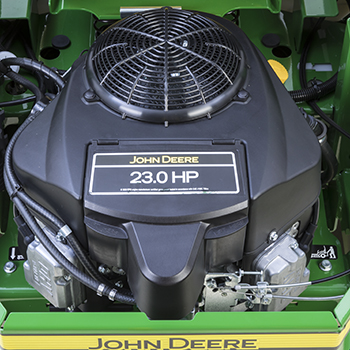 23-hp (17.2-kW) engine
23-hp (17.2-kW) engine
Key engine features:
- 23 hp (17.2 kW) provides plenty of power.
- Large 44.3-cu in. (726-cc) displacement provides excellent torque.
- V-twin, 90-degree cylinder design allows for easy starts, excellent power and performance, and smooth operation.
- Engine model is FR691V.
- Many quality features are included.
- Cast-iron cylinder liners provide a long-wearing surface for longer engine life.
- Overhead V-valves allow the engine to breathe easily for excellent power and fuel economy.
- Automatic compression release provides easy starting.
- Internally vented carburetor maintains proper fuel mixture and minimizes emissions.
- Fuel shutoff solenoid stops excess fuel from entering the exhaust system and causing after bang upon shut down.
 Engine oil check/fill and drain tube
Engine oil check/fill and drain tube
 Engine debris chopper fan guard
Engine debris chopper fan guard
- Full-pressure lubrication system provides plenty of oil to the engine’s moving parts to ensure reliable operation and long life:
- No-tools oil drain is convenient to use.
- A flexible drain tube can be placed above a drain pan to eliminate oil spills.
- Replaceable oil filter keeps the oil cleaner for a longer engine life and extends the time between oil changes.
- A rotating metal grass chopper screen helps keep the engine fins clean by filtering out debris and reducing the size of material that gets through so it will pass harmlessly past the engine fins.
- The guard keeps out large pieces of debris and provides protection from the rotating fan.
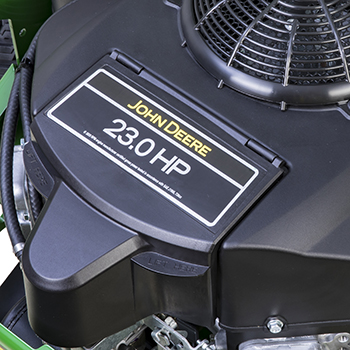 Easy service flip-up air filter cover
Easy service flip-up air filter cover
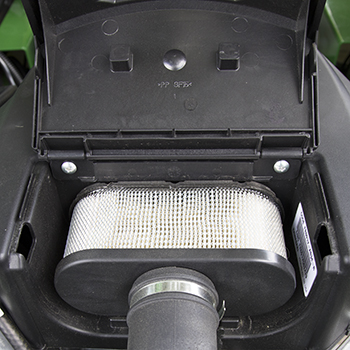 Replaceable air filter element
Replaceable air filter element
- The air filter system thoroughly cleans the engine intake air.
- Cover flips up for easy filter service.
- Electronic ignition contributes to fast starts.
 Rear engine guard
Rear engine guard
- A rear engine guard protects the engine and provides additional vehicle strength and integrity.
- A flywheel alternator provides plenty of capacity to quickly recharge the battery and power electrical equipment, such as lights.
- 20-amp capacity
- Regulated to keep the battery at a full charge without risk of overcharging
John Deere recommends the use of fuel stabilizer in gasoline. See Fuel-Protect for gasoline engines (8 oz [237 mL]) for more information.
8-gal. (30.3-L) fuel capacity for extended mowing times
 Easy-to-see fuel sight gauge
Easy-to-see fuel sight gauge
 Large fuel-fill opening and angled fuel filler neck
Large fuel-fill opening and angled fuel filler neck
The large-capacity fuel tank is easy to fill, and a convenient fuel level gauge is provided:
- Holds 8-gal. (30.3-L) of fuel to reduce time needed for refills
- Easy to see how much fuel is in the tank by viewing the sight gauge when approaching from the front of the machine
- Large, 3.5-in. (8.9-cm) fuel fill diameter for easy filling and minimum chance of spills
- Fuel fill location low for easy filling, within easy reach of the operator
John Deere recommends the use of fuel stabilizer in gasoline. See Fuel-Protect for gasoline engines (8 oz [237 mL]) for more information.
Transmission offers speeds up to 8 mph (12.8 km/h) to maximize mowing efficiency
 Dual Hydro-Gear® transmissions (Z740R shown)
Dual Hydro-Gear® transmissions (Z740R shown)
Dual transmissions efficiently power the ZTrak™ mower forward and reverse and give steering capability:
- The unitized hydrostatic drive features a hydraulic pump combined with a heavy-duty wheel motor into a single unit.
- One pump and motor transmission to drive each wheel provides several benefits:
- Exceptional cooling in high-load conditions
- Easy-to-check fluid level and refill with hydraulic oil
- Hydraulic oil check/fill accessed by raising the seat
- Transmissions are set low in the vehicle for excellent hillside stability.
- Heavy-duty components stand up to the higher loads from the larger tires and greater weight of Z700 Series ZTrak Mowers.
- Low maintenance, unitized transmissions are sealed and have no hose connections to leak hydraulic fluid.
- Four-bolt hubs provide a reliable and convenient wheel-mounting system.
The hydrostatic drive features two Hydro-Gear ZT-3100® transmissions for superior performance and durability:
- Unitized hydraulic pumps and commercial-grade, heavy-duty wheel motors combined into a single unit
- Speeds up to 8 mph (12.8 km/h)
- Pump displacement: 0.61 cu in. (10 cc) per revolution
- Motor displacement: 0.97 cu in. (16 cc) per revolution
- Durable 1-in. (2.54-cm) axles for heavy loads
- Standard shock valves for added system protection
- Standard charge pump for increased performance
- External oil filter for easier maintenance
Expansion tanks and tow valve controls
 Transmission expansion tank and filler cap
Transmission expansion tank and filler cap
 Tow-valve control, right
Tow-valve control, right
Transmission fluid expansion tanks are provided for each transmission. Yellow filler cap is easy to find and identify.
Tow-valve controls are provided for each transmission:
- Controls are located on the transmissions near the expansion tanks where they are easy to reach and use.
- Tow valves allow moving the machine in its neutral position when the engine is not running.
- Simply, pull up on the rods and secure them into the slot. When finished moving the machine, return the rods to the operating position.
Hydro-Gear and ZT-3100 are trademarks of Hydro-Gear Limited Partnership AF Holding Company, a Delaware Corporation and Danfoss Power Solutions (US) Company, a Delaware Corporation.
Operator station is adjustable for superior comfort
 Operator station
Operator station
 Fully-adjustable operator area
Fully-adjustable operator area
The operator station is designed to provide superior operator comfort for many different operators:
- Adjustable foot platform
- Ample legroom for comfortable operation
- Adjustable seat position, armrests, and suspension to suit many operators
- Dialed in for operator height and weight
- Adjustable motion-control levers
- Upper and lower positioning combined with forward and rearward tilt offers more legroom and hand positions
Adjustable foot platform
 Adjustable foot platform
Adjustable foot platform
 Large foot platform
Large foot platform
The patent-pending, adjustable three-position toe board allows any operator to quickly adjust the footrest position for greatest comfort:
- Easily and without tools, each operator can adjust the location of the footrest area to the most suitable position.
- Adjustment range of 2 in. (5.1 cm)
- Large operator platform allows a wide range of foot positions.
Adjustable seat
 Seat with adjustable armrests
Seat with adjustable armrests
 Fore-aft seat adjustment lever
Fore-aft seat adjustment lever
A deep, padded seat combined with adjustable armrests, adjustable fore/aft position, and adjustable suspension springs optimizes comfort for the operator:
- High-back, 21-in. (53.3-cm) seat comes with adjustable armrests and 4-in. (10.2-cm) fore-aft adjustment.
- Seat-adjustment lever is located at the front edge of the seat for easy use by the operator while seated.
 Seat springs in rearward position
Seat springs in rearward position
 Seat springs in forward position
Seat springs in forward position
Two steel springs under the seat absorb shocks when traveling over rough areas to provide a smoother ride:
- Four seat spring positions adjust for operator weight and preference.
- A rearward position may be more suitable for heavier and taller operators and a more forward position for lighter and shorter operators.
- 4-in. (10.2-cm) long steel springs have plenty of travel to give a smooth ride.
 Spring-loaded seat latch
Spring-loaded seat latch
The seat is securely held down for operator comfort and safety, but is easy to raise when necessary:
- A spring-loaded latch locks seat down when it is lowered.
- The seat is easy to release and raise to access adjustable seat springs.
Additional information about the seat is available at: High-quality seat with adjustable springs and armrests for extra comfort
Adjustable steering levers
 Steering levers in use
Steering levers in use
 Steering levers, shown in operation position
Steering levers, shown in operation position
Adjustable steering levers are shaped for operator comfort and ease of controlling vehicle speed and direction.
 Steering lever height adjustment, low
Steering lever height adjustment, low
 Steering lever height adjustment, high
Steering lever height adjustment, high
The steering levers offer 18 different positions to accommodate operator preference for hand placement and leg clearance.
Cup holder and storage compartment
 Deluxe cup holder with provision for cup handle
Deluxe cup holder with provision for cup handle
 Protected storage shown with battery cover removed
Protected storage shown with battery cover removed
Operator convenience is provided with easy-to-reach deluxe cup holder and storage areas.
- Cup holder includes room for a cup with a large handle.
- Covered storage under the battery access panel provides protection for important items.
High-quality seat with adjustable armrests and springs for extra comfort
 Seat with armrests
Seat with armrests
 Fore-aft seat adjustment lever
Fore-aft seat adjustment lever
A deep padded seat combined with adjustable armrests, adjustable fore/aft position, and adjustable suspension springs optimizes comfort for the operator:
- High-back, 21-in. (53.3-cm) seat with adjustable armrests and 4-in. (10.2-cm) fore-aft adjustment
- Seat-adjustment lever located at the front edge of the seat for easy use by the operator while seated
 Armrest in raised position
Armrest in raised position
 Armrest angle adjustment knob
Armrest angle adjustment knob
Armrests can be raised for easier entry and exit from the machine.
Infinite angle adjustment of the armrest can be made by an easy-to-use thumbscrew.
 Seat springs in rearward position for heavier operators
Seat springs in rearward position for heavier operators
 Seat springs in forward position for lighter operators
Seat springs in forward position for lighter operators
Two steel springs under the seat absorb shocks when traveling over rough areas to provide a smoother ride:
- Four seat-spring positions adjust for operator weight and preference.
- Rearward position may be suitable for heavier and taller operators and the forward position for lighter and shorter operators.
- Long, 4-in. (10.2-cm) springs have plenty of travel to give a smoother ride.
 Spring-loaded seat latch
Spring-loaded seat latch
The seat is securely held down, but easy to raise when necessary:
- A spring-loaded latch locks seat down when it is lowered.
- The seat is easy to release and raise to access adjustable seat springs.
Controls, including an automatic motion-control lever/parking brake system, are easy to find and use
Control panel
 Control panel, Z720E, Z735E
Control panel, Z720E, Z735E
The operator control panel is conveniently located to the right of the operator. The following controls are found on the right-hand console:
- Key switch
- Hour meter
- Ignition switch
- Power take-off (PTO) control
- Engine speed control
- Engine choke control
- Mower cut-height dial
- Mower transport position lock
- Space for the optional light kit switch
Adjustable steering levers
 Steering levers in operating position
Steering levers in operating position
 Steering levers in park position
Steering levers in park position
Motion control levers are shaped and located for operator comfort and ease of control.
 18-position control lever adjustment, low
18-position control lever adjustment, low
 18-position control lever adjustment, high
18-position control lever adjustment, high
The motion-control levers can be adjusted to two different height settings and nine different fore-aft settings:
- Combined height and fore/aft positions gives 18 adjustments
- Increased operator comfort with more leg room and more hand positions
- Adjustable for most precise control of the machine
Tracking adjustment
On-board tracking adjustment can be made by the operator from the operator seat.
- A 13-mm socket wrench is required.
Parking brake integrated with motion-control levers for extra convenience
 Motion control levers in, parking brake in disengaged position
Motion control levers in, parking brake in disengaged position
 Motion control levers out, parking brake in engaged position
Motion control levers out, parking brake in engaged position
A patent-pending automatic parking brake system is designed into the steering control levers:
- The mechanical parking brake is operated by the steering control levers.
- The parking brake is engaged when the steering control levers are moved outward, and it is disengaged when the steering control levers are moved inward to the operating position.
- An audible click lets the operator know the brake has fully engaged or disengaged.
The internal parking brake rotor and puck are continually lubricated and cooled for dependable operation and long life.
Mower deck lift/cut-height adjustment
 Mower deck lift pedal
Mower deck lift pedal
 Mower lift-assist spring
Mower lift-assist spring
Mower deck cutting height adjusts from 1.5 in. (3.8 cm) to 5 in. (12.7 cm) in 0.25-in. (0.64-cm) increments for excellent cut quality and performance:
- The foot-lift pedal is used to raise the mower deck for setting cut height or locking in the raised or transport position.
- A lift-assist spring is provided to optimize the effort it takes to raise the mower deck.
 Mower deck cut-height adjustment dial
Mower deck cut-height adjustment dial
 Mower deck transport lock
Mower deck transport lock
- To adjust cut height, simply push down on the foot-lift pedal, adjust the dial, and release the foot-lift pedal to lower the deck to the chosen height.
- Use the foot-lift pedal to lock the deck in transport mode. Simply depress the pedal all the way and the deck will lock into transport mode.
- To unlock and lower the deck, push down on the foot-lift pedal, pull up on the transport unlock lever and release the foot-lift pedal to lower the deck to the chosen height.
Safety interlock system
 Interlock switch is located under the seat
Interlock switch is located under the seat
 Operator presence system seat switch
Operator presence system seat switch
Safety interlocks help prevent operating in an unsafe way:
- The parking brake must be engaged for the engine to crank.
- Parking brake is set when motion-control levers are in the outward position.
- The operator presence system requires the operator to be in the seat to operate the PTO.
- The key switch interlock prevents bypass starting.
- If the operator leaves the seat when the PTO is engaged, controls are in the operating position, or the parking brake is not set, the engine will shut down.
- The seat interlock switch disengages the mower when the operator leaves the seat.
- The engine will stall if the operator leaves the seat without the motion-control levers in the outward position and the parking brake set.
Serviceability is designed-in for convenience
4-year bumper-to-bumper warranty*
Exclusive, 4-year, single-source, bumper-to-bumper warranty is included for all John Deere Z700 Series ZTrak mowers. The warranty places John Deere at the forefront of the mowing industry. It is hassle free, with one company handling all of the paperwork.
Z720E, Z735E |
4-year, 500-hour warranty |
Z730M, Z735M |
4-year, 750-hour warranty |
Z740R |
4-year, 1000-hour warranty |
Service interval decal
 Daily service decal
Daily service decal
A convenient service decal gives basic maintenance information. It provides a quick reference for keeping recommended service up to date. It is located underneath the battery cover.
Flip-up foot platform for mower deck access
 Operator foot platform
Operator foot platform
 Easy-to-remove foot platform (Z720E shown)
Easy-to-remove foot platform (Z720E shown)
The professional-style steel foot platform is easy to remove without tools:
- Makes cleaning grass off the top of the mower deck easier
- Provides convenient access to the mower deck for service
Engine service
 Engine oil check/fill and drain tube (Z720E, Z730M, Z740R)
Engine oil check/fill and drain tube (Z720E, Z730M, Z740R)
 Engine oil check/fill and drain tube (Z735E, Z735M)
Engine oil check/fill and drain tube (Z735E, Z735M)
The engines are easy to service, including changing the oil and the oil filter and servicing the air filter:
- The engine oil check/fill tube is located at the top of the engine and easy to see and reach.
- No-tools oil drain is convenient to use. A flexible oil drain tube is included to conveniently drain oil into a pan, thus eliminating oil spills.
 Engine air filter panel (Z735E engine shown)
Engine air filter panel (Z735E engine shown)
 Air filter cover removed (Z735E shown)
Air filter cover removed (Z735E shown)
 Multi-stage canister air filter system (Z740R shown)
Multi-stage canister air filter system (Z740R shown)
 Air filter element (Z740R shown)
Air filter element (Z740R shown)
Engine air filters are at the top of the engine for easy service:
- Z720E, Z735E, Z730M, and Z735M engines have knobs to remove the filer cover.
- The Z740R has a heavy-duty, multi-stage canister air filter system, which uses a round primary and secondary filter that are easily accessed with latches on the end cap.
Grease fittings
 Top of the mower deck
Top of the mower deck
Only three grease fittings require service:
Three to lubricate the mower-blade spindles, two easily accessed from the spindle covers, and the third by removing the foot platform.
Battery accessibility
 Battery cover
Battery cover
 340 CCA battery
340 CCA battery
The battery is protected from debris, dust, and moisture:
- It is easy to access under the panel on the left-hand side of the machine.
- Held in place by an easy-to-remove thumbscrew
- Powerful 340 cold cranking amp (CCA) battery provides dependable starts.
 Easy-to-clean flat-top mower deck
Easy-to-clean flat-top mower deck
 Flip-up spindle cover for easy cleanout and maintenance
Flip-up spindle cover for easy cleanout and maintenance
Serviceability is designed into the mower deck:
- Easy access is provided by the removable operator foot platform.
- Flat-top design minimizes places for debris to collect.
- Spring-loaded, flip-up belt guards make removing debris easy.
- A provision is provided for a standard, 3/8-in. (9.5-mm) ratchet wrench to be used for releasing belt tension when removing the drive belt.
Mower deck serviceability
 Floating deck mounting system
Floating deck mounting system
 Deck-level adjustment
Deck-level adjustment
A patent-pending deck-leveling system provides easy adjustment at all four mower mounting points:
- Loosen the nut (B) slightly with a 15-mm wrench.
- Using the open end of a 16-mm wrench on the hex fastener (A), raise or lower the deck as needed so the height of the rear blade tip is 3 to 6 mm (1/8 to 1/4 in.) higher than the front blade tip.
- Tick marks on bracket (C) are provided to aid in observing movement.
- When the deck is at the height needed, tighten the nut (B).
Transmission bypass (tow valves)
 Tow-valve control, right (knob pictured in neutral position)
Tow-valve control, right (knob pictured in neutral position)
Tow-valve controls are provided for each transmission:
- Controls are located at the rear of the machine and are easy to access.
- Tow valves allow moving the machine in its neutral position when the engine is not running.
- Simply, loosen the knob, push towards the front of the machine, and tighten the knob back. When finished moving the machine, return the rods to the operating position.
Built-in tie-down locations
 Built-in front tie-down location, right side
Built-in front tie-down location, right side
 Built-in front tie-down location, left side
Built-in front tie-down location, left side
 Built-in rear tie-down location, right side
Built-in rear tie-down location, right side
 Built-in rear tie-down location, left side
Built-in rear tie-down location, left side
Four tie-down locations are provided for convenience and safety when trailering the machine.
Operator digital video disc (DVD)
An operation and safety DVD is provided with each machine. Please consult the operator’s manual for other safety and operating procedures.
*Term limited to years or hours used, whichever comes first, and varies by model. See the LIMITED WARRANTY FOR NEW JOHN DEERE TURF AND UTILITY EQUIPMENT at JohnDeere.com or JohnDeere.ca/TUWarranty for details.
High-capacity (HC) PRO Mower Decks offer superior cut quality and versatility
 Z720E with 54-in. (137-cm) HC PRO Mower Deck
Z720E with 54-in. (137-cm) HC PRO Mower Deck
 Z735M with 60-in. (152-cm) HC PRO Mower Deck
Z735M with 60-in. (152-cm) HC PRO Mower Deck
Each Z700 Series ZTrak™ Mower is equipped with either a 48-in. (122-cm), 54-in. (137-cm), or 60-in. (152-cm) HC PRO Mower Deck.
Mower/vehicle compatibility
| High-capacity (HC) mower deck | ZTrak model | |||||
| Z720E | Z735E | Z730M | Z735M | Z740R | Z740R with Tweel® tire technology | |
| 48-in. (122-cm) High-capacity PRO | X | X | X | |||
| 54-in. (137-cm) High-capacity PRO | X | X | X | X | X* | |
| 60-in. (152-cm) High-capacity PRO | X | X | X | X | X | X* |
*Not compatible with material collection system (MCS)
Deep deck design
 Deep, flat-top deck
Deep, flat-top deck
 Deep-deck mower design
Deep-deck mower design
The mower deck has a deep-deck design:
- Constructed from heavy, 9-gauge, 0.15-in. (3.8-mm) steel.
- Minimizes the number of welds required
- Has a smooth underside for reduced material buildup
- Deep-deck design delivers excellent airflow, so large volumes of material can be processed quickly and efficiently.
- A wider and higher discharge opening provides even clipping dispersal for an excellent finished appearance in all conditions.
- A durable plastic deflector spreads grass clippings evenly across the lawn, is hinged, and can be raised to minimize the storage space required.
- 1-in. (25.4-mm) cold-forged spindles are heat-treated for strength and are supported by ball bearings.
- Standard front rollers and two double-captured wheels provide a more even mowing job and reduce the chance of scalping.
- Adjustable for different mowing heights
- The front edge is raised above the blade plane to allow for even cutting of tall grass.
- Blade overlap is greater than many conventional decks for a clean cut.
- The mower can side-discharge, mulch, or collect material, except a Z740R equipped with Tweel tires is not compatible with a material collection system.
 Mower level adjustment
Mower level adjustment
- Deck leveling and rake angle adjustment is provided at all four mower mounting points.
Step weldment
 Operator step welded on mower deck
Operator step welded on mower deck
A permanent step weldment is located at the left front corner of the mower deck:
- Encourages proper entry to the operator station
- Provides a good gripping surface for the operator’s foot
Reinforced leading edge
 Reinforced leading edge of mower deck
Reinforced leading edge of mower deck
 Trim side of mower reinforcement/wear bar
Trim side of mower reinforcement/wear bar
Steel reinforcing bars are welded to the front edge and trim side of the mower deck:
- Strengthens the deck to reduce chance of damage from obstructions
- Increased material thickness for longer life of the deck
Superior durability is designed in
 Deep mower deck spindle pocket
Deep mower deck spindle pocket
 Flip-up spindle cover
Flip-up spindle cover
The deck has deep, strong spindle pockets to keep the blades aligned, even after years of tough operation:
- Ribs formed in the deck shell add strength where it is needed.
- The aluminum spindle housing has 8-in. (20-cm) base for extra strength.
Flip-up spindle covers make cleaning the spindle area convenient.
Wheels and rollers
 Right mower anti-scalp wheel and center rollers
Right mower anti-scalp wheel and center rollers
 Left mower anti-scalp wheel
Left mower anti-scalp wheel
Dual-captured front and side anti-scalp wheels:
- Give a more even mowing job and reduce the chance of scalping
- Adjustable for different mowing heights
Optional MulchControl™ attachment
The MulchControl attachment makes mulching more practical for many mowing situations because it not only does an excellent job of mulching but it also allows the mower to be easily converted for times when it is more desirable to side discharge or collect the lawn material.
Advantages of mulching grass clippings include:
- A beautiful looking lawn
- Grass clippings not blown onto the operator, driveways, or flower beds
- Less fertilizer use
- Elimination of the effort needed to dispose of clippings
How MulchControl works
 Illustration of MulchControl baffle open
Illustration of MulchControl baffle open
 Illustration of MulchControl baffle closed
Illustration of MulchControl baffle closed
MulchControl is an innovative, simple design that is easy to use and maintain:
- The MulchControl attachment includes baffles to control the flow of material under the deck.
- The left mower blade area is completely enclosed and optimized for mulching and will mulch even when the mower is in the side-discharge mode.
- Baffles around the center and right blades are optimized for mulching when the discharge baffle is closed.
- The attachment also includes mulching blades.
Optional 6.5-bu (229-L) ZTrak Z700 Series MCS
 6.5-bu (230-L) hopper and included weights (chute, blower and attachment bar sold separately)
6.5-bu (230-L) hopper and included weights (chute, blower and attachment bar sold separately)
 6.5-bu (230-L) rear hopper, chute, attachment bar, and blower
6.5-bu (230-L) rear hopper, chute, attachment bar, and blower
The 6.5-bu (230-L) rear bagger efficiently collects material from a 48-, 54-, or 60-in. (122-, 137-, or 152-cm) Mower Deck:
- Hopper, attachment bar/bumper, Power Flow™ blower, and chute components are ordered separately to make a complete MCS.
- A weight bracket and four 18-lb (8.2-kg) weights are included for installation on the front of the vehicle to help counterbalance the weight of the hopper. For proper ballast with complete MCS:
- Four weights are required on a ZTrak Z700 Series equipped with a 48-in. (122-cm) Mower Deck.
- Three weights are required on a ZTrak Z700 Series equipped with a 54-in. (137-cm) Mower Deck.
- Two weights are required on a ZTrak Z700 Series equipped with a 60-in. (152-cm) Mower Deck.
MulchControl handle is used to control baffle
 MulchControl baffle closed
MulchControl baffle closed
 MulchControl handle in closed position
MulchControl handle in closed position
The MulchControl handle is located on top of the mower deck and used to open and close the discharge baffle:
- The operator is required to get off of the machine in order to engage or disengage mulch mode.
- MulchControl is well suited to the following mowing situations:
- Operators who usually mulch, but side-discharge when grass gets too long
- Operators who usually side discharge, but would like to be able to close the chute to control clippings
- Operators who always mulch a main lawn, but often side discharge secondary lawns
- Operators who bag clippings, but want to go farther before emptying bags
MulchControl puts the operator in control of the clippings. The operator can have all the benefits of mulching with the ability to easily change to side-discharge or bagging when needed.
MulchControl limitations
While in the side-discharge mode, MulchControl will still mulch about one third of the material. Therefore, the side-discharge mode is essentially a partial-mulch mode. This can be an advantage when side discharging or bagging, as it helps to reduce the amount of material being discharged. Other times this could work as a disadvantage:
- When cutting strong southern grasses, such as Zoysia and Bermuda
- When cutting in wet, high-growth conditions, such as those found in the Pacific Northwest United States
- When optimum bagging and lawn clean-up is desired
Compatibility
MulchControl is a field-installed attachment and compatible with the 48-in. (122-cm), 54-in. (137-cm), and 60-in. (152-cm) HC PRO Mower Decks available for the Z700 Series ZTrak Mowers.
 Removing bag from 6.5-bu (230-L) hopper
Removing bag from 6.5-bu (230-L) hopper
 Removing bag from 6.5-bu (230-L) hopper
Removing bag from 6.5-bu (230-L) hopper
The hopper design provides efficient bagging performance, clean operation, and easy-to-empty bags:
- Two durable bags give a generous, 6.5-bu (230-L) capacity.
- The bags lift out for easy emptying.
- An efficient chute provides a smooth flow of material to reduce the chance of plugging.
- The chute and Power Flow blower must be ordered separately.
- Standard mower blades are used for bagging.
- The air exhaust duct directs air from the hopper back and toward the ground for clean operation.
- Convenient latch makes opening and closing the hopper easy.
NOTE: Appropriate hopper, Power Flow blower, chute, and attachment bar are required and ordered separately.
Specifications
Capacity |
6.5 bu (230 L) |
Material: |
|
Hopper top |
High impact polypropylene |
Chute |
Polyethylene |
Blower housing |
Nylon |
Fan |
Ultra-high molecular weight (UHMW) polyethylene |
Bags |
Polyester |
Filling |
Directly into bags for emptying on ground or in trailer or into plastic liners |
Fan diameter |
13 in. (33 cm) |
Fan width |
2.75 in. (7 cm) |
Number of fan blades |
Four |
NOTE: MulchControl attachments and MCS components are not included in base equipment for a Z700 Series ZTrak machine and must be ordered separately.
Tweel is a trademark of Michelin North America, Inc.
Features
Engine is powerful and smooth-running premium V-twin design
 18.5-hp (13.8-kW) engine
18.5-hp (13.8-kW) engine
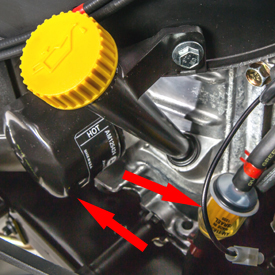 Engine oil and fuel filters
Engine oil and fuel filters
The S240 Tractor comes with a premium engine, the same as used in some Select Series™ X300 models:
- Large cleanout ports, integrated into the engine shroud, are located over the cylinder heads to allow for easy inspection and removal of any debris that may have collected there.
- Premium engine oil and air filtering systems and cooling design provide increased reliability and engine life.
The 18.5-hp (13.8-kW) V-twin engine provides plenty of power and torque to handle tough mulching, mowing, and bagging conditions:
- V-twin cylinder design for greater torque, lower vibration, and improved sound quality
- Electronic ignition for fast starts
- Cast-iron cylinder liners for longer engine life
- Overhead valves for excellent power and fuel economy
- Full-pressure lubrication and oil filter for cleaner oil, prolonging engine life and extending the time between oil changes
- Also more effective when operating the tractor on an incline
- In-line fuel filter for reliable operation
 Engine speed lever and spring-loaded choke lever
Engine speed lever and spring-loaded choke lever
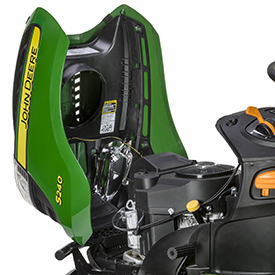 Engine hood in open position
Engine hood in open position
The engine speed lever and choke control lever are separate controls:
- The engine speed lever is easy to use - there is no need to worry about pushing too far and engaging the choke as on single throttle/choke lever systems.
- The choke lever is spring loaded so the operator cannot accidentally operate the tractor with the choke on.
Engine hood opens wide for easy access to service points:
- It is easy to inspect and clean the engine area.
- Important service points are exposed.
- Cleanout ports designed into the engine shroud make cleaning the engine cooling fins easy.
- The high-quality engine used in the S240 does not require an 8-hour oil and filter change because improvements in the manufacturing process and quality of parts, components, and oils have eliminated the need for the short interval oil change requirement.
Fuel tank has gauge to show fuel level from the operator's seat
 Fuel tank gauge
Fuel tank gauge
 Convenient fuel-filler opening
Convenient fuel-filler opening
The fuel tank gauge shows how much fuel is in the tank, and can be seen without leaving the operator's seat:
- Easy to check the fuel level
- Convenient location
Fuel tank:
- Capacity is 2.4 U.S. gal. (9.08 L).
- Fuel-filler opening is conveniently located under the seat.
- Filling the tank without spilling is easy.
- The tethered fuel tank cap is more convenient.
- The sealed fuel cap helps keep vapors inside the tank.
- The tractor has a California Air Resources Board (CARB) certified engine for reduced air pollution.
The 48-in. (122-cm) Accel Deep™ Mower Deck cuts clean and is versatile
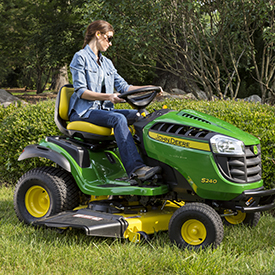 S240 with Accel Deep Mower
S240 with Accel Deep Mower
 Left front corner of mower deck
Left front corner of mower deck
The 48-in. (122-cm) Accel Deep Mower Deck is a stamped-steel, deep, flat-top design that delivers excellent cut quality, productivity, cleanliness, durability, and versatility. Optimal performance and dispersion of clippings is provided, even at faster mowing speeds:
- 4.83-in. (12.3-cm) depth throughout the entire deck shell allows for optimum mowing, mulching, and bagging performance.
- Optional MulchControl™ attachment provides superior mulching performance and versatility.
- Stamped-steel design eliminates sharp edges and corners where material can build up and diminish mowing performance.
- Mower deck is suspended from the vehicle for a smooth and level cut.
- Adjustable mower wheels, positioned just above ground level, help reduce scalping.
Excellent cut quality
 Top view of mower deck
Top view of mower deck
 Underside of mower deck
Underside of mower deck
NOTE: Optional front center rollers shown in above mower deck photos.
Deep mower-deck stamping gives excellent cut quality. It allows the cut and suspended material room to exit the deck without getting recut:
- Reducing the amount of re-cutting enables more power to be used to cut incoming grass, which greatly improves mower capacity.
- Helps maintain excellent cut quality at faster mowing speeds
- Clean flow of material out of the discharge area prevents cut material from interfering with cutting the incoming grass, making it possible for the blades to cut incoming material cleanly.
- Even in mulching mode, cut evenness is improved compared to other designs because the additional depth allows for continuous circulation, optimal re-cutting, and an even distribution of clippings.
Productivity - getting the job done fast
 Left side of Accel Deep mower deck
Left side of Accel Deep mower deck
 Right side of Accel Deep mower deck
Right side of Accel Deep mower deck
Deep mower-deck stamping gives high productivity, which gets the job done fast. It allows the cut and suspended material room to exit the deck quickly, reducing the amount of re-cutting so more power is available to process incoming grass:
- Greatly improves mowers capacity to maintain excellent mowing performance in difficult mowing conditions and at higher speeds
Large discharge opening is both high and wide to handle more material:
- Gives a smooth, even discharge of clippings at all mowing speeds
- Reduces the chance of plugging, especially important when operating in wet, thick, or dense grass and when bagging
Cleanliness - for the mower and the operator
 Right front view of mower deck
Right front view of mower deck
 Left front view of mower deck
Left front view of mower deck
The flat-top shape of the deck stamping is optimal for keeping the deck and the operator clean:
- There are few places to catch and hold material on top and underneath the deck.
- Top of deck stays cleaner, reducing time and effort needed for cleaning and service
- Underside of deck is self-cleaning to maintain optimum performance without build-up of material to interfere with the flow of air and clippings
- Less need to clean and remove build-up of material from underside deck
- The depth of the Accel Deep mower deck minimizes the amount of material that escapes from the front of the deck.
- Limited amount of material drifts onto the operator and mower deck
- Even for material discharged out of the chute, less re-cutting results in larger pieces that are less likely to end up on the operator
- Mulching prevents the discharge of material completely, and the MulchControl attachment makes mulching a practical solution for most mowing situations.
Cleaning a mower deck, both top and bottom, is one of the most frequent maintenance activities:
- The flat-top design reduces places for material to build up and makes material that does collect easy to remove.
 Mower wash port
Mower wash port
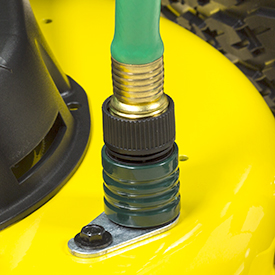 Mower wash port with hose connector
Mower wash port with hose connector
A wash port is provided to make cleaning the underside of the mower deck easy.
- A hose connector is included with the mower deck.
Superior durability is designed in
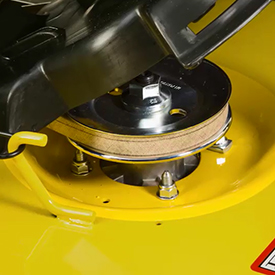 Spindle pocket with flip-up cover
Spindle pocket with flip-up cover
 Easy-to-adjust mower wheel and mower side reinforcement
Easy-to-adjust mower wheel and mower side reinforcement
The 48A Mower Deck has strong spindle pockets, to keep the blades aligned, even after years of tough service:
- Ribs in the deck shell add strength where it is needed.
Mower wheels are heavy duty:
- Provides greater strength and durability for longer, trouble-free life.
- Setting wheels to the correct height for the cutting height is quick and easy.
Low-tension belt-drive design reduces the side load on engine lower bearings and mower deck bearings for longer life.
The mower deck features a 5/8-in. (16-mm) diameter solid-steel rod side bumper that provides extra strength and protection.
Dual-stage E-coat and powder-paint coatings provide extra protection from rust.
Versatility - easy to change between side discharge, mulch, and bagging modes
The 48-in. (122-cm) Mower Deck is designed for maximum versatility, providing the greatest ease in changing from one mower discharge mode to another:
- With the optional MulchControl attachment installed (along with the special mulching blades), changing from side-discharge to mulching or vice versa is done with the simple flip of a lever.
- The Power Flow rear bagger can be used with the MulchControl attachment and blades installed - by simply placing the MulchControl lever in the side-discharge position.
Front roller option
Optional front rollers are available for the 48A Mower Deck to reduce the chance of scalping when mowing over berms and other uneven areas. Parts required are:
- Two M113955 rollers
- One M158262 screw
- One M142955 locknut
MulchControl option
The MulchControl attachment for the 48A Mower Deck makes mulching more practical for many mowing situations because it not only does an excellent job of mulching but it also allows the mower to be easily converted for times when it is more desirable to side discharge or collect the lawn material. Advantages of mulching grass clippings include:
- A beautiful looking lawn
- Grass clippings not blown onto the operator, driveways, or flower beds
- Less fertilizer use
- Elimination of the effort needed to dispose of clippings
How MulchControl works
 MulchControl baffle open
MulchControl baffle open
 MulchControl baffle closed
MulchControl baffle closed
NOTE: Optional front center rollers shown in above mower deck photos.
MulchControl is an innovative, simple design that is easy to use and maintain:
- The MulchControl attachment includes baffles to control the flow of material under the deck.
- The MulchControl baffle, or divider, between the left and middle spindles is about half way down. The height is designed to balance the mulching and side-discharge modes.
- When the MulchControl baffle is open, the divider between the left and middle spindles passes a portion of the material to the discharge opening, along with the material from the middle and right spindle areas.
- When the MulchControl baffle is closed, the material stays within the deck and gets chopped into mulch and deposited in the turf.
 MulchControl baffle closed
MulchControl baffle closed
 MulchControl handle
MulchControl handle
- The MulchControl handle is located on top of the mower deck and used to open and close the discharge baffle.
- The operator is required to get off of the machine in order to engage or disengage mulch mode.
- Changing from mulching to side discharge or vice versa takes only a few seconds.
MulchControl is well-suited to the following mowing situations:
- For operators who usually mulch, but side discharge when grass gets too long
- For operators who usually side-discharge, but would like to be able to close the chute to control clippings
- For operators who always mulch a main lawn, but often side discharge secondary lawns
- For operators who bag clippings, but want to go farther before emptying bags
MulchControl puts the operator in control of the clippings. Now the operator can have all the benefits of mulching with the ability to easily change to side discharge or bagging when needed.
While in the side-discharge mode, MulchControl will still mulch about one third of the material. Therefore, the side-discharge mode is essentially a partial-mulch mode. This can be an advantage when side discharging or bagging, as it helps to reduce the amount of material being discharged. Other times this could work as a disadvantage:
- When cutting strong southern grasses, such as Zoysia and Bermuda
- When cutting in wet, high-growth conditions, such as those found in the Pacific Northwest United States
- When optimum bagging and lawn clean-up is desired
6.5-bu (229-L) Power Flow™ rear bagger option
 Optional rear bagger
Optional rear bagger
 Power Flow blower
Power Flow blower
An optional 6.5-bu (229-L) rear bagger material collection system (MCS) is available. It provides an efficient means of collecting grass clippings and leaves:
- The Power Flow blower and chute are easy to install. The Power Flow blower swings out for easy cleanout and cleanup.
- The hopper design provides modern styling, great bagging performance, cleaner operation, and easy-to-empty bags:
- 6.5-bu (229-L) capacity
- Easy-to-attach Power Flow blower
- Easy-to-attach chute
Three-year or 200-hour bumper-to-bumper warranty is standard
An exclusive 3-year or 200-hour (whichever comes first), single-source, bumper-to-bumper warranty* is standard for all John Deere S200 Series Tractors.
- The warranty is hassle free, with one company handling all of the paperwork.
- Premium features of S200 Series Tractors allow for this longer warranty period, with more coverage than comparable tractors.
*Term limited to years or hours used, whichever comes first, and varies by model. See the LIMITED WARRANTY FOR NEW JOHN DEERE TURF AND UTILITY EQUIPMENT at JohnDeere.com or JohnDeere.ca/TUWarranty for details.
Hydro/automatic drive gives an infinite choice of ground speeds
 Two-pedal foot control and cruise lever
Two-pedal foot control and cruise lever
 Hydro/automatic foot control in use
Hydro/automatic foot control in use
A Kanzaki® Tuff Torq® hydro/automatic transmission gives an infinite choice of speeds and makes changing the direction of travel easy.
Side-by-side foot pedals control the speed and direction of travel:
- The automotive-type accelerator controls ensure easy operation.
- The operator can change direction without lifting foot off the platform.
- A large pedal surface gives superior operator comfort.
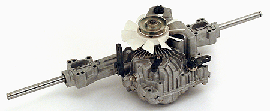 Hydro/automatic-transmission
Hydro/automatic-transmission
Appropriate transmissions are used in each model, depending on rear tire size and tractor performance requirements to ensure excellent performance and reliability:
-
The S240 Tractor has a Tuff Torq K46DP transaxle with an internal wet-disk brake for reliability and long life:
-
Rated for 30 percent more torque than the transaxle used in many lawn tractors
-
Uses Hy-Gard™ fluid like Select Series™ X300 Tractors
-
Standard cruise control
 Cruise control lever
Cruise control lever
Easy-to-use cruise control option maintains the tractor's speed for mowing larger areas.
-
To engage, lift up on the cruise lever and hold it until foot is removed from the forward pedal.
-
To disengage, lightly press and then release the forward pedal.
-
For emergency stops, cruise can be released by pushing on the brake pedal or pushing down on the cruise control lever.
Kanzaki and Tuff Torq are trademarks of Kanzaki Kokyukoki Manufacturing Company.
Snow removal is a strength of lawn tractors
 Snow blower, weather enclosure, weights, and chains on a 100 Series Tractor
Snow blower, weather enclosure, weights, and chains on a 100 Series Tractor
 Front blade, weather enclosure, and chains on a 100 Series Tractor
Front blade, weather enclosure, and chains on a 100 Series Tractor
An advantage of lawn tractors is their ability to use equipment for snow removal. Lawn tractor owners can add a John Deere snow blower or front blade to make quick work of moving snow whenever the need arises. Weather enclosure and tire-chain attachments add comfort and performance.
Equipment available for snow removal includes:
- 44-in. (112-cm) Snow Blower
- 46-in. (117-cm) Front Blade
- Tire chains or TerraGrip traction belts
- Weather enclosure
- Weights
Full-length, welded-steel frame and cast-iron front axle for reliability
 S240 Tractor
S240 Tractor
 Solid, one-piece frame and cast-iron front axle
Solid, one-piece frame and cast-iron front axle
Enhanced styling for the S240 Tractor includes a unique hood top:
- Close-out panels at the lower back of the hood are included for better looks and reduced engine sound level.
- Top louvers improve engine cooling.
The solid one-piece frame is constructed of 12-gauge, 0.105-in. (2.7-mm) steel:
- Full-length robotically welded frame design has high-strength steel rails for added strength and long life.
- One-piece fender deck is bolted to the frame.
- Two-bar front bumper is included as standard equipment to add style and protection.
 S240 Tractor
S240 Tractor
 Turf Trac tire tread
Turf Trac tire tread
The S240 comes with premium Turf Trac tires for superior traction and appearance:
- A more rounded profile reduces lawn scuffing and steering effort.
Cast-iron front axle will not bend
 Front axle and wheel spindle
Front axle and wheel spindle
The front axle is constructed of solid cast iron that will not bend:
- Automotive-like steering system with sector-and-pinion steering gears and single drag link and tie rod provides a very strong, low-effort, and tight-turning system.
- Grease fittings allow regular lubrication to help maintain easy steering and minimize wear.
- Large, 0.75-in. (19-mm) diameter wheel spindles provide excellent durability.
- Front wheels turn on ball bearings for increased reliability and life over other lawn tractors that have bushing for the front wheels.
CargO Mount™ system makes installation of rear bagger and other attachments easy
 Rear CargO Mount points
Rear CargO Mount points
 Front CargO Mount points
Front CargO Mount points
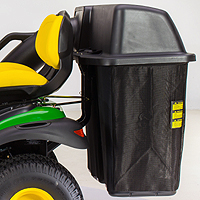 Rear bagger is mounted with the rear CargO Mount points
Rear bagger is mounted with the rear CargO Mount points
The CargO Mount system is a combination of front and rear mounting points that provide convenient and easy installation of the rear bagger and other attachments.
Operator station designed for comfortable operation
Large, comfortable footrests
 S240 with Accel Deep Mower
S240 with Accel Deep Mower
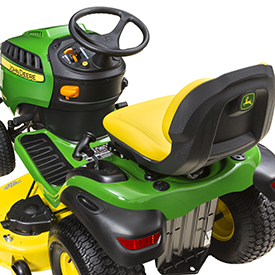 Comfortable operator station, left side
Comfortable operator station, left side
Wide footrest areas with non-slip, anti-vibration rubber footpads are provided for operator comfort and safety:
- Channels in the footrest design steer debris off to the side to keep the foot platform cleaner.
- Wider footrest makes it easier to step over the mower deck while entering or exiting the seat.
Comfortable seat
 Open-back seat
Open-back seat
 Easy-to-adjust seat
Easy-to-adjust seat
The operator seat can be easily adjusted forward or rearward while in the seat, with seat travel of 5.5 in. (140 mm) and 10 different positions:
- The open-back seat design keeps the operators back cooler.
- The green plastic seat adjustment lever is easy to locate and use.
- Slide pads on the bottom of the seat allow the seat to slide more easily for convenient adjustment.
 Rubber isolators under the seat give a smoother ride
Rubber isolators under the seat give a smoother ride
The seat can be tilted forward for protection from the elements and to provide easy access to the fuel tank:
- Rubber isolators under the seat smooth out the ride for greater operator comfort.
Convenient storage and service-interval decal
 Storage compartment with cover
Storage compartment with cover
 Convenient service-interval decal
Convenient service-interval decal
The beverage holder and storage compartment, located on the right fender, add value and operator convenience.
A decal located inside the hood gives quick access to basic service information.
Instruments and controls are easy to find and convenient to use
Controls and instruments
 Conveniently located controls
Conveniently located controls
Three-spoke steering wheel for greater operator comfort and control:
- Large, 14-in. (35.6-cm) diameter steering wheel gives greater comfort and control compared to smaller diameter steering wheels used on many lawn tractors.
The contoured dash has clean, attractive styling:
- Controls are color coded and labeled for easy identification by the operator.
- Controls are logically placed and easy to reach.
- The hour meter makes it easy to tell when oil changes and other maintenance should be performed.
- The ignition switch is on the dash for starting ease.
- Functional design of the controls provides good appearance and a comfortable feel.
 Engine speed lever and spring-loaded choke lever
Engine speed lever and spring-loaded choke lever
 Power take-off (PTO) switch
Power take-off (PTO) switch
The engine speed lever and choke control lever are separate controls:
- The engine speed lever is easy to use - there is no need to worry about pushing too far and engaging the choke as on single throttle/choke lever systems.
- The choke lever is spring loaded so the operator cannot accidentally operate the tractor with the choke on.
Mower drive is actuated with an easy-to-use electric PTO switch:
- The electric switch requires only a short movement compared to long throw required with manual PTO engagement lever.
- With an electric PTO clutch, the mower drive belt stays under tension at all times for improved reliability compared to manual PTO engagement systems.
Reverse implement option (RIO)
 RIO switch
RIO switch
Using RIO
CAUTION: Children or bystanders may be injured by rotating blades. Before traveling forward or rearward:
- Carefully check the area around the machine.
- Disengage the mower before backing up.
NOTE: Backing up while the mower is engaged is strongly discouraged. RIO should be used only when operating another attachment or when the operator deems it necessary to reposition the machine with the mower engaged.
- Stop forward travel.
- Look behind the machine to be sure there are no bystanders.
- Push and hold in the RIO switch while depressing the reverse pedal slightly.
NOTE: If the mower or other attachment stops while repositioning the machine, return the attachment engagement switch to the off position. Start engine and engage mower. Begin again with step 2.
- Release the RIO switch and reposition the machine as the machine begins to move rearward.
- Resume forward travel. The mower or other attachment should continue operating.
- Repeat procedure to position the machine again.
Cruise control
 Cruise control lever
Cruise control lever
 Cruise control lever and two-pedal foot control
Cruise control lever and two-pedal foot control
Cruise control is standard equipment:
- To engage, lift up on the cruise lever and hold until the foot is removed from the forward pedal.
- For emergency stop, the cruise control can be released by pushing on the brake pedal or the forward pedal.
Parking brake control
 Parking brake control
Parking brake control
 Brake pedal and parking brake control
Brake pedal and parking brake control
The parking brake control is conveniently located for easy access. It holds the brake pedal securely in the locked position.
Mower deck height adjustment and handgrip
 Mower deck height adjustment lever
Mower deck height adjustment lever
 Fender flare with handgrip
Fender flare with handgrip
The spring-assisted, low-effort lift lever simplifies setting and adjusting the mower cut height:
- Increments of 0.25 in. (0.64 cm) allow for fine-tuning the cut height.
Full-size fender flares include handgrips and reflectors for added safety.
Serviceability is convenient with easy-open hood
 One-piece hood is easy to open
One-piece hood is easy to open
 Service interval decal located under hood
Service interval decal located under hood
The one-piece hood opens easily to permit checking and servicing the engine:
- Important service points are located within easy reach.
- A service interval decal is provided inside the tractor hood for convenience when servicing the tractor.
- The high-quality engine used in the S240 does not require an 8-hour oil and filter change because improvements in the manufacturing process and quality of parts, components, and oils have eliminated the need for the short interval oil change requirement.
 Easy-to-service engine fuel and oil filters
Easy-to-service engine fuel and oil filters
 Easy access to fuel-fill opening
Easy access to fuel-fill opening
The engine fuel and oil filters, the oil check/fill tube, and the oil drain tube are exposed for serviceability when the hood is opened.
The seat tilts up and out of the way to make adding fuel easy.
The S240 Tractor is covered by a 3-year/200-hour bumper-to-bumper warranty*:
- Premium features of the S240 allow for this longer warranty period, with more coverage than other tractors of comparable size.
*Term limited to years or hours used, whichever comes first, and varies by model. See the LIMITED WARRANTY FOR NEW JOHN DEERE TURF AND UTILITY EQUIPMENT at JohnDeere.com or JohnDeere.ca/TUWarranty for details.
Hood will not dent or rust and includes quality headlights for good visibility
 One-piece hood opens for service access
One-piece hood opens for service access
 Quality headlights for good visibility
Quality headlights for good visibility
The hood is made of molded-in color material:
- Reduces sound
- Will not rust or dent
- Openings on the side of the hood let in plenty of cooling air while keeping the sound level low.
- Two headlights provide good lighting for nighttime operation.
The MowerPlus™ app helps maintain the tractor and lawn
 MowerPlus app screen
MowerPlus app screen
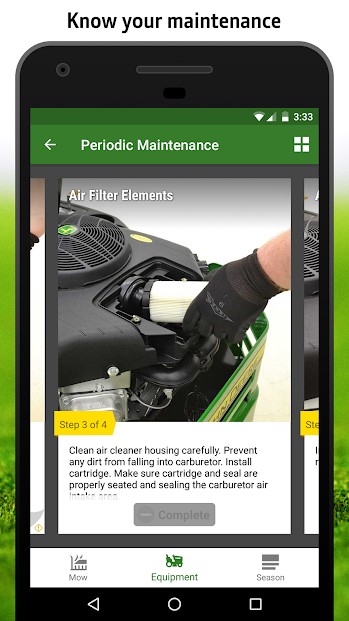 MowerPlus app maintenance screen
MowerPlus app maintenance screen
Keep a John Deere riding lawn mower running its best and know how it mows with the John Deere MowerPlus app. Simply scan the lawn tractor’s barcode to get custom information. The app helps determine the best time to mow, communicates expert pre-mow tips, offers maintenance reminders, and provides walk-through guides.
Look for the MowerPlus app on the iOS® or Android™ system app stores.
The app supports residential lawn equipment such as 100 Series, S240, X300, X500, X700, Z200 through Z600, and many similarly-sized older products. It does not presently support tractor models numbered 1000 and larger, such as 1025R.
NOTE: Some product image variation may exist.
MowerPlus hour meter connector also available (sold separately)
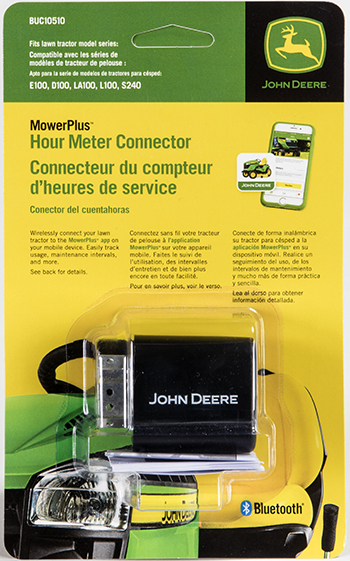 MowerPlus hour meter connector packaging
MowerPlus hour meter connector packaging
The John Deere MowerPlus hour meter connector wirelessly links a 100 Series or S240 Lawn Tractor to the MowerPlus app on a mobile device. The hour meter connector transmits engine usage to the app, making it easy to track maintenance intervals:
- iOS version 10 or higher is compatible with the hour meter connector.
- Android versions are not compatible with the hour meter connector at this time.
iOS is a trademark of Cisco Technology, Inc. used under license by Apple Inc. Android is a trademark of Google LLC.
Features
Cyclonic V-twin engine is smooth running and powerful
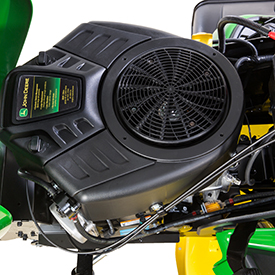 20-hp (14.9-kW) engine
20-hp (14.9-kW) engine
 20-hp (14.9-kW) engine
20-hp (14.9-kW) engine
The 20-hp (14.9-kW) V-twin engine used in the Select Series™ X330 Tractor provides plenty of power and torque to handle tough mulching, mowing, and bagging conditions:
- V-twin cylinder design for greater torque, lower vibration, and improved sound quality
- Large, 44.2-cu in. (724-cc) displacement
- More torque to get the job done faster
- Large displacement and camshaft and carburetor designs create the optimum torque rise for rapid response to varying load conditions
- Electronic ignition for fast starts
- Cast-iron sleeves for longer engine life
- Overhead valves for excellent power and fuel economy
- Full-pressure lubrication and oil filter for keeping the oil cleaner for a long engine life and extending the time between oil changes; full-pressure lubrication is also more effective when operating the tractor on an incline
- Excellent serviceability with easily replaced air filter, fuel filter, and oil filter and a convenient oil-drain hose to make draining the oil easy and clean
Cyclonic air filter
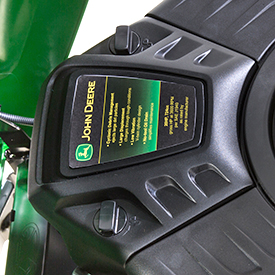 Air filter cover
Air filter cover
 Air filter with foam precleaner
Air filter with foam precleaner
Cyclonic air-management system removes larger particles of dirt before they reach the air filter for reduced filter maintenance and longer engine life:
- Cyclonic design ejects large dirt particles before they make contact with the filter.
- Large, high-quality dry-type paper element air filter thoroughly cleans engine intake air.
- The cover over the air filter is easily removed with two knobs for cleaning or replacement of the filter.
Serviceability
 Engine oil check/fill tube and oil-drain hose
Engine oil check/fill tube and oil-drain hose
 Oil drain hose
Oil drain hose
Engine oil check and fill tube is conveniently located for easy access. Oil drain hose makes draining oil easy and clean.
Fuel tank has large, 3.3-U.S. gal. (12.5-L) capacity
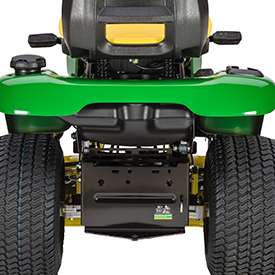 Fuel tank
Fuel tank
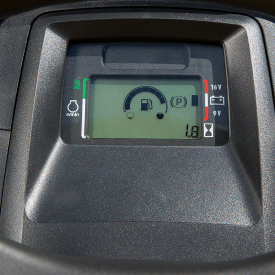 Electronic fuel gauge
Electronic fuel gauge
Large fuel tank and convenient fuel gauge minimize the number of stops for fuel and chance of running out of fuel:
- Fuel tank has a large, 3.3-U.S. gal. (12.5-L) capacity for more hours of operation between refills.
- Large, 3-in. (7.6-cm) diameter fuel tank filler opening makes adding fuel easy.
- Located on the left fender
- Helps eliminate spillage
- Electronic fuel gauge on the dash display allows the operator to easily monitor the amount of fuel in the tank.
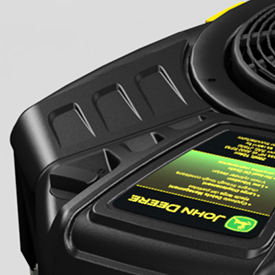 Debris inspection port cover
Debris inspection port cover
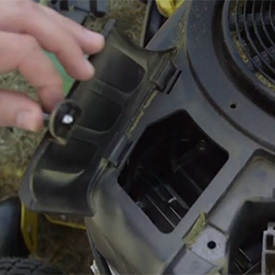 Debris inspection port
Debris inspection port
Two debris inspection ports help ensure clean engine fins for optimum cooling. Bolts to open them are conveniently located under the air filter cover.
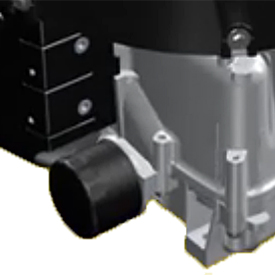 Engine oil filter
Engine oil filter
 Replaceable engine oil filter and fuel filter
Replaceable engine oil filter and fuel filter
Replaceable oil filter and fuel filter are easy to access and change to minimize service time and cost.
The 48-in. (122-cm) Accel Deep™ (48A) Mower Deck cuts clean and is versatile
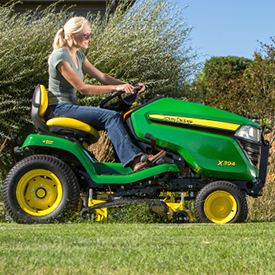 X394 with Accel Deep 48A Mower
X394 with Accel Deep 48A Mower
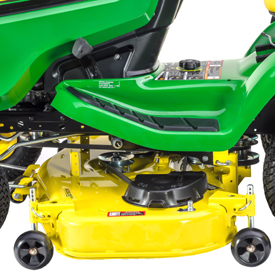 Accel Deep 48A Mower
Accel Deep 48A Mower
The 48-in. (122-cm) Accel Deep Deck uses the latest in three-spindle mowing technology to raise performance to a higher level:
- 10-gauge, 0.135-in. (3.4-mm) deck stamping for long life
- Deep, flat-top deck design to handle a large volume of material at faster mowing speeds
- Gives excellent cut quality and uniform discharge
- Easy to keep clean on top of and under the deck
- Resilient four-point mounting system suspends mower from tractor for a smooth and level cut
- Wide mower wheels easily adjusted just above ground level to help prevent scalping
- 0.25-in. (6.4-mm) cut-height increments allow mower to be set at the desired cut height
- Onboard deck-leveling system makes keeping mower properly adjusted easy
- Compatible with optional MulchControl™ mulching system
- Compatible with high-performance Power Flow™ material collection systems
- For use on X330, X350, X354, X370, X380, X384, X390, X394, X570, X580, X584, and model year 2016 X590 Tractors
The 48-in. (122-cm) Accel Deep Mower Deck is a stamped-steel, deep, flat-top design that delivers excellent cut quality, productivity, cleanliness, durability, and versatility. Optimal performance and dispersion of clippings is provided, even at faster mowing speeds:
- 4.83-in. (12.3-cm) depth throughout the entire deck shell for optimum mowing, mulching, and bagging performance
- Optional lever-action or electric one-touch MulchControl attachment provides superior mulching performance and versatility.
- Stamped-steel design eliminates sharp edges and corners where material can build up and diminish mowing performance
- Mower deck is suspended from the vehicle for a smooth and level cut
- Adjustable mower wheels, positioned just above ground level, help reduce scalping
Excellent cut quality
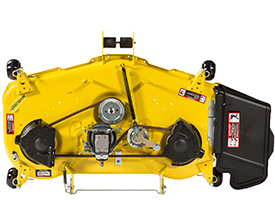 48A Mower top (similar mower from X700 Series Tractor shown)
48A Mower top (similar mower from X700 Series Tractor shown)
 48A Mower underside (similar mower from X700 Series Tractor shown)
48A Mower underside (similar mower from X700 Series Tractor shown)
Deep mower-deck stamping gives excellent cut quality. It allows the cut and suspended material room to exit the deck without getting recut:
- Reducing the amount of re-cutting enables more power to be used to cut incoming grass, which greatly improves mower capacity.
- Helps maintain excellent cut quality at faster mowing speeds
- Clean flow of material out of discharge area prevents cut material from interfering with cutting the incoming grass, making it possible for the blades to cut incoming material cleanly.
- Even in mulching mode, cut evenness is improved compared to other designs because the additional depth allows for continuous circulation, optimal re-cutting, and an even distribution of clippings.
Productivity - getting the job done fast
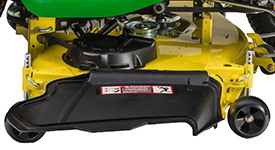 Right side of Accel Deep 48A Mower Deck
Right side of Accel Deep 48A Mower Deck
Deep mower-deck stamping gives high productivity, which gets the job done fast. It allows the cut and suspended material room to exit the deck quickly, reducing the amount of re-cutting so more power is available to process incoming grass:
- Greatly improves mowers capacity to maintain excellent mowing performance in difficult mowing conditions and at higher speeds
Large discharge opening is both high and wide to handle more material:
- Gives a smooth, even discharge of clippings at all mowing speeds
- Reduces the chance of plugging, especially important when operating in wet, thick, or dense grass and when bagging
- The 48A Power Flow blower has an inlet housing with over 50 percent greater area than the 48X Power Flow blower used on previous machines.
Cleanliness - for the mower and the operator
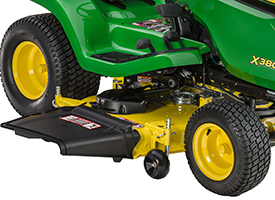 Accel Deep 48A Mower Deck
Accel Deep 48A Mower Deck
 Accel Deep 48A Mower Deck
Accel Deep 48A Mower Deck
The flat-top shape of the deck stamping is optimal for keeping itself and the operator clean:
- There are few places to catch and hold material on top and underneath the deck.
- Top of deck stays cleaner, reducing time and effort needed for cleaning and service
- Underside of deck is self-cleaning to maintain optimum performance without buildup of material to interfere with the flow of air and clippings
- Less need to clean and remove buildup of material from underside deck
- The depth of the Accel Deep mower deck minimizes the amount of material that escapes from the front of the deck:
- Limited amount of material to drift onto the operator and mower deck
- Even for material discharged out the chute, less re-cutting results in larger pieces that are less likely to end up on the operator
- Mulching prevents the discharge of material completely and the MulchControl attachment makes mulching a practical solution for most mowing situations.
Cleaning a mower deck, both top and bottom, is one of the most frequent maintenance activities:
- The flat-top design reduces places for material to build up and makes material that does collect easy to remove.
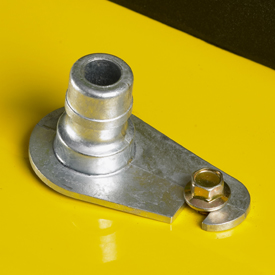 Mower wash port
Mower wash port
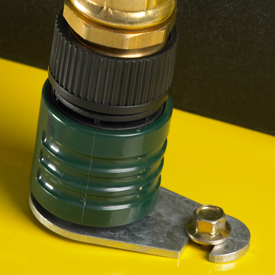 Mower wash port with hose connector
Mower wash port with hose connector
A wash port is provided to make cleaning the underside of the mower deck easy.
- Hose connector is included with the mower deck.
Superior durability is designed in
 Spindle pocket with flip-up cover
Spindle pocket with flip-up cover
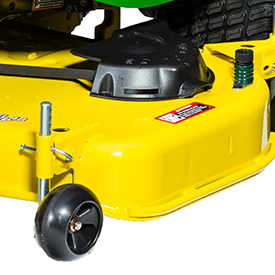 Easy-to-adjust mower wheel and mower side reinforcement
Easy-to-adjust mower wheel and mower side reinforcement
The 48A Mower Deck has strong spindle pockets, to keep the blades aligned, even after years of tough service:
- Ribs in the deck shell add strength where it is needed.
- The 48A has a 23 percent heavier overall weight than the Edge™ Xtra 48-in. (122-cm) mower deck used on previous machines.
Mower wheels are heavy duty:
- Provides greater strength and durability for longer, trouble-free life.
- Setting wheels to the correct height for the cutting height quick and easy.
Low-tension belt-drive design reduces the side load on engine lower bearings and mower deck bearings for longer life.
The 48A Mower Deck features a 5/8-in. (16-mm) diameter solid-steel rod side bumper that provides extra strength and protection.
Dual-stage E-coat and powder-paint coatings provide extra protection from rust.
Versatility - easy to change between side discharge, mulch, and bagging modes
The 48A Mower is designed for maximum versatility, providing the greatest ease in changing from one mower discharge mode to another:
- With an optional MulchControl attachment installed (along with the special mulching blades), changing from side-discharging to mulching or vice versa is done with the simple flip of a lever or push of an electric switch.
- The Power Flow rear bagger can be used with the MulchControl attachment and blades installed by simply using the MulchControl lever or electric one-touch switch to move the mulch baffle to the side-discharge position.
MulchControl option
A lever-action or electric one-touch MulchControl attachment for the 48A Mower Deck makes mulching more practical for many mowing situations because it not only does an excellent job of mulching but it also allows the mower to be easily converted for times when it is more desirable to side discharge or collect the lawn material. Advantages of mulching grass clippings include:
- A beautiful looking lawn
- Grass clippings not blown onto the operator, driveways, or flower beds
- Less fertilizer use
- Elimination of the effort needed to dispose of clippings
How MulchControl works
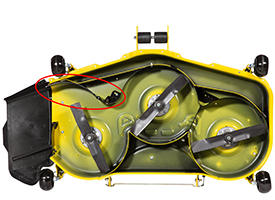 MulchControl baffle open
MulchControl baffle open
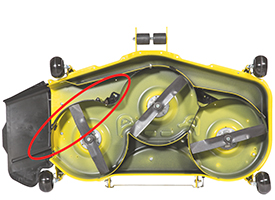 MulchControl baffle closed
MulchControl baffle closed
MulchControl is an innovative, simple design that is easy to use and maintain:
- The MulchControl attachment includes baffles to control the flow of material under the deck.
- The MulchControl baffle, or divider, between the left and middle spindles is about half way down. The height is designed to balance the mulching and side-discharge modes.
- When the MulchControl baffle is open, the divider between the left and middle spindles passes a portion of the material to the discharge opening, along with the material from the middle and right spindle areas.
- When the MulchControl baffle is closed, the material stays within the deck and gets chopped into mulch and deposited in the turf.
 MulchControl handle
MulchControl handle
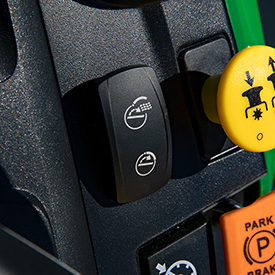 Electric one-touch MulchControl switch
Electric one-touch MulchControl switch
- For the lever-action MulchControl attachment, a handle on top of the mower deck is used to engage or disengage mulch mode.
- The operator is required to get off of the tractor in order to engage or disengage mulch mode with the lever-action system.
- For the electric one-touch MulchControl attachment, a switch on the tractor dash is used to engage or disengage mulch mode.
- Changing from mulch mode to side discharge mode or vice versa takes only a few seconds.
MulchControl is well-suited to the following mowing situations:
- Usually mulch, but side discharge when grass gets too long
- Usually side-discharge, but would like to be able to close the chute to control clippings
- Always mulch a main lawn, but often side discharge secondary lawns
- Bag clippings, but want to go farther before emptying bags
MulchControl puts the operator in control of the clippings. The operator can have all the benefits of mulching with the ability to easily change to side discharging or bagging when needed.
While in the side-discharge mode, MulchControl will still mulch about one third of the material. Therefore, the side-discharge mode is essentially a partial-mulch mode. This can be an advantage when side discharging or bagging, as it helps to reduce the amount of material being discharged. Other times this could work as a disadvantage:
- When cutting strong southern grasses, such as Zoysia and Bermuda
- When cutting in wet, high-growth conditions, such as those found in the Pacific Northwest United States
- When optimum bagging and lawn clean-up is desired
7-bu (247-L) Power Flow rear bagger
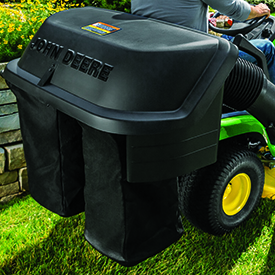 Optional rear bagger
Optional rear bagger
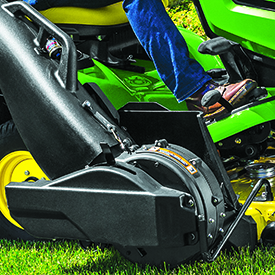 Power Flow blower
Power Flow blower
An optional 7-bu (247-L) rear bagger material collection system (MCS) is available. It provides an efficient means of collecting grass clippings and leaves:
- The Power Flow blower and chute are easy to install. The Power Flow blower swings out for easy cleanout and cleanup.
- The hopper design provides modern styling, great bagging performance, cleaner operation, and easy-to-empty bags:
- 7-bu (247-L) capacity
- Easy-to-attach Power Flow blower (ordered separately)
- Easy-to-attach chute (ordered separately)
- Air exhaust duct
- Convenient spring-latch
- Airflow fill indicator
- Quik-Tatch mounting
- Sealed hopper top
- Loose-knit bags available
Larger 14-bu (493-L) and 19-bu (670-L) MCS are available, in addition to the 7-bu (247-L) MCS, for specific X300 and X500 Series Tractor models.
Four-year or 300-hour bumper-to-bumper warranty is standard
An exclusive 4-year or 300-hour (whichever comes first), single-source, bumper-to-bumper warranty* is standard for all John Deere X300 Series Tractors.
- The warranty is hassle free, with one company handling all of the paperwork.
- Premium features of X300 Series Tractors allow for this longer warranty period, with more coverage than comparable tractors.
*Term limited to years or hours used, whichever comes first, and varies by model. See the LIMITED WARRANTY FOR NEW JOHN DEERE TURF AND UTILITY EQUIPMENT at JohnDeere.com or JohnDeere.ca/TUWarranty for details.
Lever-action or electric one-touch MulchControl™ options are available for extra mowing convenience
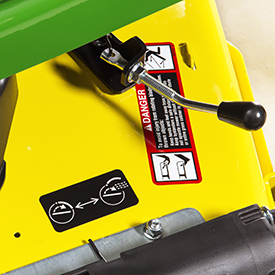 Lever-action MulchContol lever
Lever-action MulchContol lever
 Electric one-touch MulchControl switch
Electric one-touch MulchControl switch
Lever-action or electric one-touch MulchControl attachment is available for Accel Deep™ 42-in. (107-cm) (42A), 48-in. (122-cm) (48A), and 54-in. (137-cm) (54A) Mower Decks used on X300 and X500 Select Series™ Tractors.
MulchControl advantages and benefits
MulchControl enhances versatility and productivity. A mower deck equipped with MulchControl not only does an excellent job of mowing and mulching, but it can also be quickly converted from side discharging to mulching or vice versa:
- In mulch mode, it controls clippings dispersion in unwanted areas (driveways, landscape beds, near buildings, windows, parking lots, etc.).
- Reduces cleanup time needed to dispose of clippings.
- Reduces the amount of material entering a material collection system because, even in the side discharge mode, MulchControl will mulch about one third of the material due to the additional baffles under the mower deck and the unique design of the mulching blades.
Electric MulchControl has the additional advantage of being controlled from the tractor seat by a switch on the dash to operate an electric actuator that moves the baffle to close off the discharge area of the mower deck.
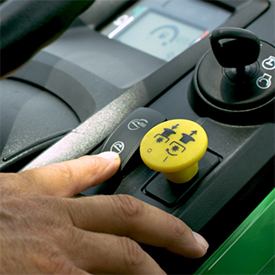 Electric one-touch MulchControl switch
Electric one-touch MulchControl switch
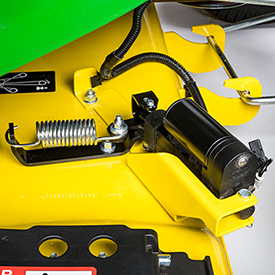 Electric one-touch MulchControl actuator
Electric one-touch MulchControl actuator
- Operators can convert between modes without interrupting the mowing process, making it practical to change between modes as conditions require.
- When approaching clean areas like driveways or flowerbeds where clippings would be undesirable
- When a breeze might blow clippings back onto the operator
- For side discharge mowing only the areas of the property where grass is too thick for mulching
- With 48A and 54A Mower Decks, for collecting only the areas of the property where grass is too tall or thick for mulching
- With 48A and 54A Mower Decks, the MulchControl baffle can be opened or closed with the Power Flow™ blower installed. The Power Flow blower will run without material when the baffle is closed.
- Models equipped with a 42A Mower Deck require a MulchControl baffle be removed to install the bagger chute; see 42A Mower Deck versatility explanation for more information.
- Changing from one mode to the other takes only a few seconds.
How MulchControl works
A mower equipped with a MulchControl attachment delivers unprecedented levels of productivity and versatility. The operator has the ability to quickly change between side discharging and mulching. A heavy-duty baffle opens and closes to convert the mower from side discharge mode to mulch mode or vice versa.
 MulchControl baffle open (similar mower deck shown)
MulchControl baffle open (similar mower deck shown)
 MulchControl baffle closed (similar mower deck shown)
MulchControl baffle closed (similar mower deck shown)
MulchControl is an innovative, simple design that is easy to use and maintain:
- The MulchControl attachment includes baffles to control the flow of material under the deck.
- When the MulchControl baffle is open, most of the material flows freely out the discharge deflector or into a material collection system.
- When the MulchControl baffle is closed, material stays within the deck and gets chopped into mulch and deposited in the turf.
MulchControl is well-suited to the following mowing situations:
- For operators who usually mulch, but side discharge when grass gets too long
- For operators who usually side discharge, but would like to be able to close the chute to control clippings in some areas
- For operators who always mulch a main lawn, but often side discharge secondary lawns
- For operators who collect clippings, but want to go farther before emptying the material collection system
MulchControl puts the operator in control of the clippings. The operator can have all the benefits of mulching with the ability to easily change to side discharging when desired.
Advantages of MulchControl include:
- Performance is improved.
- Mulching is beneficial because it returns the clippings to the ground as fertilizer, which promotes lawn growth.
- Clippings are much smaller, which allows them to fall into the grass and be removed from view.
- Unsightly grass clippings are not blown onto driveways or into flower beds.
- Fertilizer use is reduced and provides associated environmental benefits.
- Uptime is increased.
- Operators can convert quickly between modes, making it possible to change between mulching and side discharging as conditions require.
- Mulching heavy, thick material can significantly reduce mower productivity. The ability to switch from mulch to side discharge mode ensures productivity, especially in grass too tall or thick to mulch effectively.
- Cost of operation is reduced.
- Controlling clipping dispersion reduces cleanup time.
MulchControl limitations
While in the side discharge mode, MulchControl will still mulch about one third of the material. Therefore, the side discharge mode is essentially a partial mulch mode. This can be an advantage when side discharging or bagging, as it helps to reduce the amount of material being discharged. Other times this could work as a disadvantage:
- When cutting strong southern grasses, such as Zoysia and Bermuda
- When cutting in wet, high growth conditions, such as those found in the Pacific Northwest United States
- When optimum bagging and lawn cleanup is desired
- 42A Mower Deck requires a MulchControl baffle be removed to install the bagger chute
MulchControl compatibility
Each MulchControl attachment includes everything needed: baffles and mulch blades for all attachments, and the actuator, wiring, and switches for the electric one-touch attachments.
Lever-action MulchControl attachments
| Attachment number | Description | Applications |
| BM24794 | 42A MulchControl (lever action) | X300 Series Tractors, Z300 Series ZTrak™ Mowers |
| BM24993 | 48A MulchControl (lever action) | X300 and X500 Series Tractors, Z300 and Z500 Series ZTrak Mowers |
| BM24994 | 54A MulchControl (lever action) | X300 and X500 Series Tractors, Z300 and Z500 Series ZTrak Mowers |
Electric one-touch MulchControl attachments
| Attachment number | Description | Applications |
| BUC10164 | 42A electric one-touch MulchControl | X300 Series Tractors* |
| BUC10165 | 48A electric one-touch MulchControl | X300 and X500 Series Tractors* |
| BUC10166 | 54A electric one-touch MulchControl | X300 and X500 Series Tractors* |
* NOTE: Model year 2016-2017 X300 and X500 Series Tractors (X300 serial number 10,001-50,000 and X500 serial number 110,001-130,000) require replacing the tractor wiring harness and dash panel to use an electric MulchControl attachment.
Snow removal is a strength of lawn tractors
 44-in. (112-cm) Front Blade
44-in. (112-cm) Front Blade
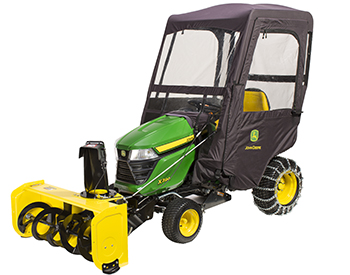 Snow blower, weather enclosure, and chains on an X300 Series Tractor
Snow blower, weather enclosure, and chains on an X300 Series Tractor
An advantage of lawn tractors is their ability to use equipment for snow removal. Lawn tractor owners can add a John Deere snow blower or front blade to make quick work of moving snow whenever the need arises. Weather enclosure and tire-chain attachments add comfort and performance.
Equipment available for snow removal includes:
- 44-in. (112-cm) Snow Blower
- 44-in. (112-cm) Front Blade
- 48-in. (122-cm) Front Blade (X394 Tractor only)
- Tire chains or TerraGrip traction belts
- Weather enclosure (available for all X300 Series, except the X350R)
- Weights
Steering is low-effort sector and pinion system
 Tight turning radius
Tight turning radius
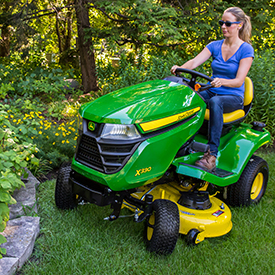 Designed for easy turns
Designed for easy turns
A heavy-duty sector and pinion steering system with quality bearings provides easy and precise control for the life of the tractor:
- Small, 16-in. (40.6-cm) turning radius provides excellent maneuverability
- Tight turning ability improves mowing efficiency
Easy steering
Easy steering is important for an enjoyable mowing experience:
-
Large, 14-in. (36-cm) diameter steering wheel for improved leverage
-
Large sector gear for improved (higher) steering ratio
-
A higher ratio equals lower steering effort
-
-
Dual drag links to help equalize the steering loads and reduce steering error
-
Ball joints on both ends of the steering tie rods for long life
-
Long steering arms to improve the mechanical advantage of the steering system through the full range of motion
- Sector gear that pivots on a shaft rather than a bushing to ensure proper gear mesh and eliminate binding
- Greaseable front steering spindles to reduce friction and improve wear over time
Integrated hydrostatic transaxle efficiently transmits power to wheels
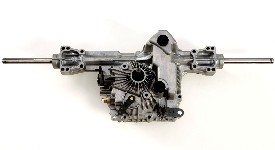 Kanzaki® K46 transaxle (X330, X350, X354) Kansaki K57 transaxle (X370)
Kanzaki® K46 transaxle (X330, X350, X354) Kansaki K57 transaxle (X370)
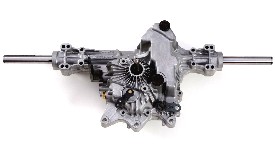 Kanzaki K58 transaxle (X380, X384, X390, X394)
Kanzaki K58 transaxle (X380, X384, X390, X394)
The Tuff Torq® hydrostatic transaxle encloses the hydrostatic pump and motor rotator groups in the same housing with the differential and axle housings. This design is very efficient and reduces the number of sealing surfaces to minimize the potential for leakage.
Combined with the foot controls, the hydrostatic transmission functions similarly to that of an automatic transmission in an automobile, so the term automatic is often used to describe it:
- Use of the latest valve designs has significantly reduced the sound level.
- Large pump and motor rotating groups ensure long life and efficient operation.
Freewheeling valve
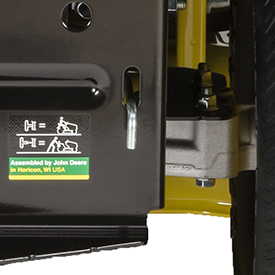 Freewheeling valve
Freewheeling valve

A freewheeling valve control is conveniently located near the tractor rear hitch plate for good visibility and easy operation.
Kanzaki and Tuff Torq are trademarks of Kanzaki Kokyukoki Manufacturing Company.
Controls and display functions are easy to identify and convenient to use
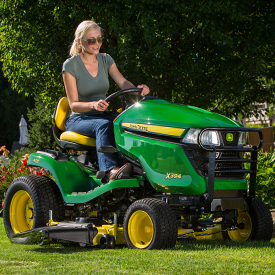 X394 Tractor mowing
X394 Tractor mowing
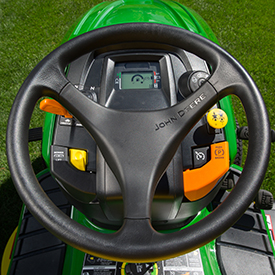 Steering wheel and controls (switch turned on to show display)
Steering wheel and controls (switch turned on to show display)
Controls
The contoured dash has clean, attractive styling and ergonomic controls for easy use:
- Controls are color coded and labeled with English words for easy identification by the operator.
- Controls are logically placed and easy to reach.
- The power take-off (PTO) switch allows the operator to get fingers underneath it, like a T-handle, to pull up for easy activation.
- The reverse implement option (RIO) switch is a yellow button.
- The latch control on foot-lift models and hydraulic-lift control on power-lift models and the park brake latch are pivot levers for low effort.
- Cruise control activation is handled by an automotive-style button.
- Separate engine speed and choke controls make starting and warming up the engine easier in cold weather.
- The choke lever is spring loaded to eliminate the chance the tractor will be unintentionally operated with the choke partially closed.
- Functional design of the throttle and choke controls provides good appearance and a comfortable feel.
Display panel
 Display panel
Display panel
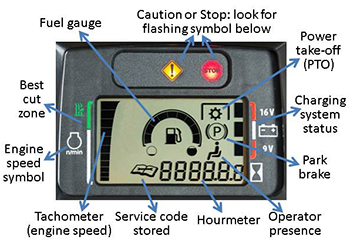 Display panel illustration with descriptions
Display panel illustration with descriptions
Instrument display has the look and feel of a modern automobile. A power-up sequence cycles lights and gauges to indicate they are working:
- Display features dark-cockpit design to minimize operator distractions.
- Display is back lit for night visibility.
- Night visibility is especially useful with snow blower use.
- Hour meter makes it easy to tell when oil changes and other maintenance should be performed.
- Electronic fuel gauge provides real-time fuel level information.
- The X350R has a low fuel light, rather than a fuel gauge, to provide the operator with a noticeable warning when low on fuel.
- A tachometer graphically displays engine speed.
- Target-zone graphics inform the operator of the engine speed range to use for best cut quality.
- An indicator tells the operator when the PTO is operating.
- Bright caution and stop lights capture the operator's attention when important information is on the instrument cluster.
- Damage can be prevented and repair costs reduced by addressing problems early.
- Operators are advised of what the problem is if they attempt to operate the mower with unsatisfied PTO, seat, or park brake interlocks.
- The indicators are also useful to identify the reasons the PTO or engine may have shut off when an interlock is unsatisfied.
- Operators are advised if battery voltage is low, normal, or excessive.
- The service indicator light illuminates to indicate a diagnostic error code is stored.
- Onboard diagnostics provides trouble codes for use by trained technicians.
- For example, a technician will be able to test switch functionality and circuit continuity without tools.
- Onboard diagnostics provides trouble codes for use by trained technicians.
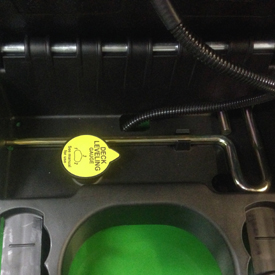 Storage tray under tractor seat
Storage tray under tractor seat
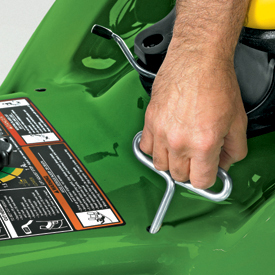 Exact Adjust tool is used to level mower deck
Exact Adjust tool is used to level mower deck
Storage for the onboard deck-leveling gauge and the Exact Adjust tool is provided in the storage tray under the tractor’s seat:
- Exact Adjust ports on the fender deck allow for easy and accurate leveling of the mower deck for optimum mowing performance.
Twin Touch™ foot control
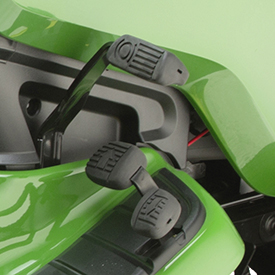 Twin Touch foot control
Twin Touch foot control
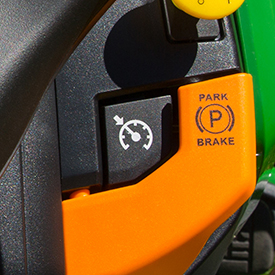 Cruise control
Cruise control
Twin Touch foot pedals control the speed and direction of travel:
- Automotive-type accelerator control ensures easy operation.
- Operator can change direction without lifting foot off the platform.
- Large pedal surface gives superior operator comfort.
Cruise control
Cruise control is standard equipment:
- To engage, push the cruise-control button and hold until the foot is removed from the forward pedal.
- For emergency stop, the cruise control can be released by pushing on the brake pedal or the forward pedal.
Mower deck height adjustment
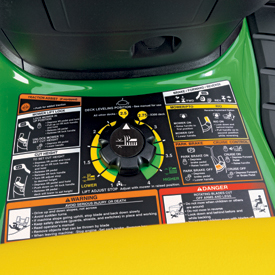 Conveniently-located deck height adjustment knob
Conveniently-located deck height adjustment knob
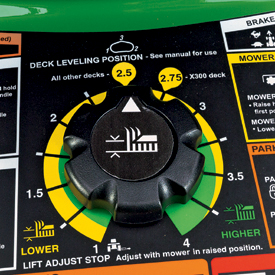 Cut height adjusting knob
Cut height adjusting knob
A rotary dial knob makes adjusting the mower cut height quick and easy:
- Provides mower cut heights in 0.25-in. (0.64-cm) increments from 1 in. (2.5 cm) to 4 in. (10.2 cm)
- Returns the mower deck to the same preset height each time it is lowered
 Deck-leveling gauge placed under deck
Deck-leveling gauge placed under deck

Deck-leveling gauge is placed at the appropriate location under the left rear, right rear, and front of the mower deck as the cut height is adjusted using the Exact Adjust tool and front draft arm adjusting nuts.
Foot-pedal lift system
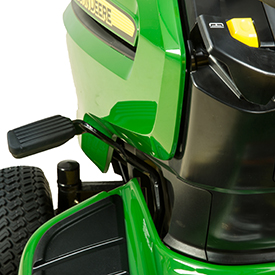 Foot-pedal lift system
Foot-pedal lift system

Pushing with the foot to raise the mower or implement is less strenuous for many operators than using a hand-lift lever:
- The easy-to-use raised position lock operates similarly to the park brake lock.
- The foot pedal is out of the way and not likely to catch on bushes and tree limbs when mowing.
- The mower deck returns to the same preset height each time it is lowered.
Adjustable lift-assist spring
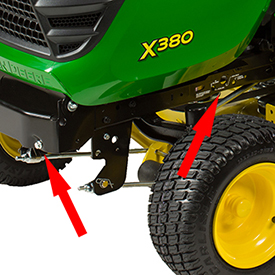 Lift-assist spring decals and adjusting bolt
Lift-assist spring decals and adjusting bolt
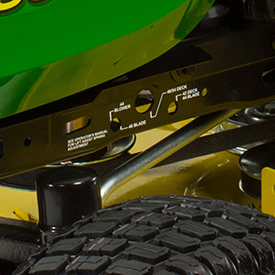 Close-up of lift-assist spring decal
Close-up of lift-assist spring decal
NOTE: The adjustable lift-assist spring is standard equipment on tractors with manual foot-lift system that are shipped with the 48-in. (122-cm) and 54-in. (137-cm) side-discharge mowers, and an option for tractors shipped with 42-in. (107-cm) mowers. It is a recommended option for foot-lift tractors sold with the 42-in. (107-cm) mulch mower.
- Lift-assist spring is provided on tractors shipped from the factory with a 48-in. (122-cm) or 54-in. (137-cm) side-discharge mower deck, except models with hydraulic lift, and a recommended option for tractors equipped with a 42-in. (107-cm) mulch mower to minimize lift effort.
-
A spring-assist kit is available for other models for use with front equipment.
-
-
Lift effort can be easily adjusted by turning a bolt, located on the tractor front bumper, for optimum performance, depending on the equipment used (mower, front blade, snow blower, etc.).
-
The mower will not be inadvertently locked in the raised position when mowing through ditches.
-
When installing or removing a mower or front equipment raised by the foot-lift system, spring tension may be removed from the connection points by pulling rearward on the lift pedal and raising the lift latch to hold the pedal in the rearward position.
Parking brake control
 Parking brake
Parking brake
Depressing the brake pedal applies internal wet-disk brakes, which provide better reliability and longer life than external brakes, for safe stopping.
The parking brake control is conveniently located for easy access. It holds the brake pedal securely in the locked position.
Using RIO
CAUTION: Children or bystanders may be injured by rotating blades. Before traveling forward or rearward:
- Carefully check the area around the machine.
- Disengage the mower before backing up.
NOTE: Operating the mower while backing up is strongly discouraged. RIO should be used only when operating another attachment or when the operator deems it necessary to reposition the machine with the mower engaged.
- Stop forward travel. Allow attachment to run.
- Look down and behind the machine to be sure that there are no bystanders.
- Push and hold in the reverse implement switch while depressing the reverse pedal slightly.
NOTE: If the attachment stops while positioning the machine, return mower engagement (PTO) switch to off position. Repeat this procedure from the beginning. - Release the reverse implement switch and reposition the machine as the machine begins to move rearward.
- Resume forward travel. The attachment should continue operating.
- Repeat procedure to position the machine again.
Reverse implement option (RIO)
 Reverse implement switch
Reverse implement switch
 Mower engagement power take-off (PTO) switch
Mower engagement power take-off (PTO) switch
Electric power take-off (PTO) clutch is easy and convenient to use
 Electric PTO switch
Electric PTO switch
The heavy-duty electric PTO clutch is operated with a convenient dash-mounted switch.
Heavy-duty PTO clutch
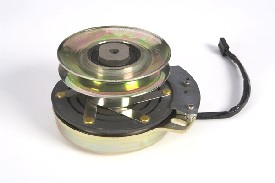 PTO clutch
PTO clutch
The PTO clutch is designed to operate through many on/off cycles.
Frame is reliable heavy-duty welded steel
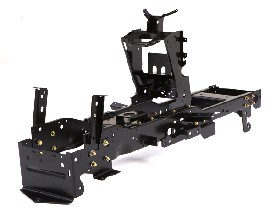 Welded, heavy-duty frame
Welded, heavy-duty frame

The frame is made of heavy formed and welded steel, reinforced in critical areas for even greater strength:
- The frame is formed from 12-gauge, 0.105-in. (2.66-mm) thick material for long life.
- Standard front bumper and hitch plate are formed from 9-gauge, 0.15-in. (3.8-mm) steel and complete the frame assembly.
- Rear hitch plate can support two 42-lb (19-kg) Quik-Tatch weights.
- Weight bracket is built into the frame of two-wheel-steer models.
- Four-wheel-steer models require the optional weight bracket.
Front axle and wheel spindles are heavy-duty
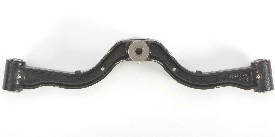 Cast-iron front axle
Cast-iron front axle
Front axle is made of nodular cast iron:
- Cast-iron front axle is strong and shock-resistant.
- Cast iron will not yield under heavy loads or impact.
A replaceable bushing is used at axle mounting:
- The bushing provides excellent wear resistance.
- Grease fittings at each spindle are easy to service.
Front steering spindles
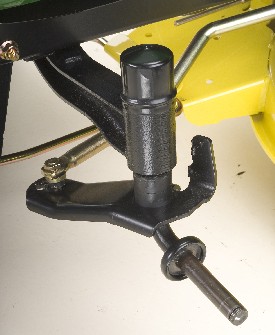 Steering spindle
Steering spindle
Front steering spindle diameter is 0.75 in. (19 mm) for strength and long life:
- Have strength to handle heavy implements
- Provide long life at bearing surfaces
- Use sealed precision bearings in front wheels
Rear equipment-mounting system is heavy-duty and easy to use
 Rear equipment mounting system
Rear equipment mounting system
A heavy-duty equipment mounting system is used:
- Includes strong frame mounts with a combination of mounting holes in the tractor hitch plate that accept pins or shoulder bolts to support heavy rear-mounted equipment.
- Easily attach optional equipment to the tractor
- Can bear the load of heavy rear-mounted equipment, such as material collection systems
Modern styling with functional design enhances appearance and performance
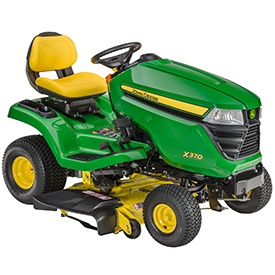 Attractive styling
Attractive styling
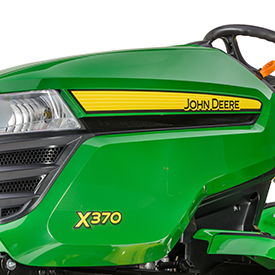 Hood air-intake louvers
Hood air-intake louvers
Smooth, rounded contours present a modern, styled appearance:
- Hood styling incorporates efficient full-length air-intake louvers on each side, rather than on the top.
- Cooler engine operation
- Lower operator station sound levels
- Hot air is vented out the front grille, away from the operator.
- The fully enclosed hood is made of molded-in-color material.
- Reduces sound
- Will not rust or dent
- Distinctive grille and large, one-piece fender deck complete the styling package.
Two high-quality headlights give excellent visibility
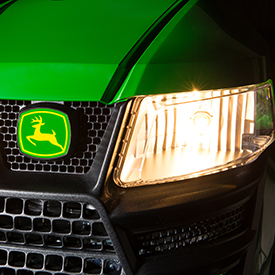 Optimum lighting pattern
Optimum lighting pattern
Headlights are standard equipment on all models:
- Two 27-W bulbs provide excellent lighting for good visibility during evening operation.
- A headlight position on the ignition switch makes it easy to operate the headlights.
- The headlights are designed to provide an optimum lighting pattern for mowing and snow removal.
Operator station is comfortable and convenient
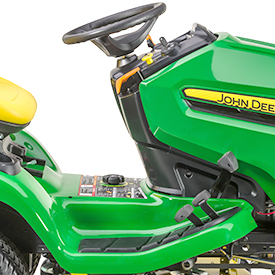 Operator station
Operator station
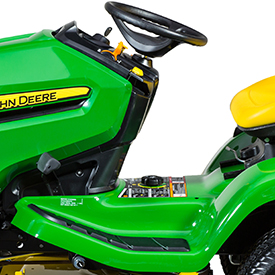 Operator station
Operator station
The operator station is designed for operator comfort and ease of using controls:
- A large, 14-in. (36-cm) diameter steering wheel is comfortable to use and minimizes steering effort.
- Full-length foot mats provide comfort for the operator and protect the footrest area.
Comfortable seat
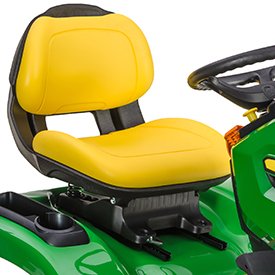 Comfortable open-back seat
Comfortable open-back seat

An open-back 15-in. (38-cm) high-back seat provides a comfortable, smooth ride and good support for the operator:
- Seat travel of 7 in. (18 cm) with 15 positions allows the operator to be seated comfortably and easily operate the controls.
- Seat can be easily adjusted fore and aft by the operator while sitting on the seat.
- Open-back design allows air circulation to keep the operator's back cool and dry for a more comfortable ride.
- Grasp at the top of the seat is conveniently located for use when tilting the seat up to protect it from the weather.
Seat suspension
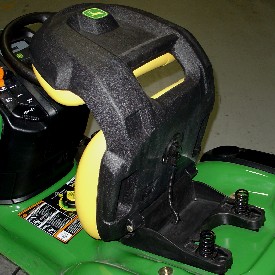 Seat suspension
Seat suspension

The seat suspension is adjustable, without tools, for the weight of the operator:
- Springs are adjustable fore and aft to any of three positions.
- No tools require
- Allows fine-tuning of the suspension for the operator's weight
- Back position for more support for heavier operators
- Tool tray is designed into the seat base.
- Can be used to store gloves, small tools, etc.
- Provides storage location for Exact Adjust tool and deck-leveling gauge (tool and depth-leveling gauge not shown in photo)
Cup holder
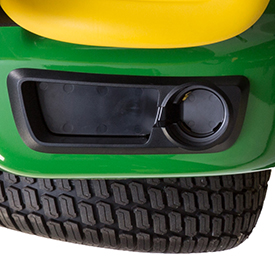 Cup holder and tool tray on fender
Cup holder and tool tray on fender
A cup holder and tool tray are located on the fender for operator convenience:
- The cup holder holds a variety of container sizes.
- Tool tray provides convenient storage.
- Cup holder and tool tray are constructed of durable acrylonitrile butadiene styrene (ABS) plastic.
Removable plug for optional 12-V outlet
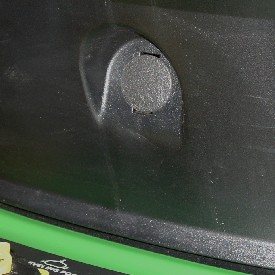 Location for optional 12-V outlet
Location for optional 12-V outlet
A removable plug on the console, in front of the operator, provides a convenient location for the optional 12-V outlet and makes installation easy.
- Convenient for plugging in cell phone charger and other electric devices
- Can be used to operate electric rear equipment, such as a sprayer or spreader
12-V fast connector
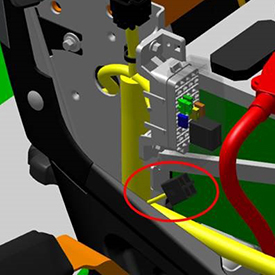 Illustration of fast connector location
Illustration of fast connector location
A mid-vehicle, 12-V fast connector, located under the tractor’s fuse box, is included as standard equipment to reduce initial installation time for some attachments that operate on 12-V power from the tractor:
- The four-cavity connector includes battery, ground, and key switch terminals and is turned on and off with the ignition switch.
Serviceability is convenient with easy-open hood
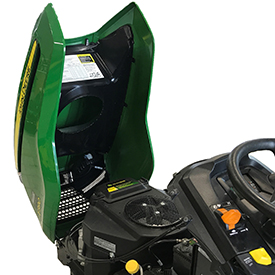 One-piece hood is easy to open
One-piece hood is easy to open
 Service interval decal located under hood
Service interval decal located under hood
The one-piece hood opens easily to permit checking and servicing the engine:
- Important service points are located within easy reach.
- A service-interval decal is provided inside the tractor hood for convenience when servicing the tractor.
- The high-quality engine used in the X300 Series does not require an 8-hour oil and filter change because improvements in the manufacturing process and quality of parts, components, and oils have eliminated the need for the short interval oil change requirement.
 Easy-to-service engine fuel and oil filters
Easy-to-service engine fuel and oil filters
The engine fuel and oil filters, the oil check/fill tube, and the oil drain tube are exposed for serviceability when the hood is opened.
Exact Adjust ports and onboard deck-leveling tools make precise deck adjustments easy
 Deck-leveling gauge and hex adjusting tool stored under tractor seat
Deck-leveling gauge and hex adjusting tool stored under tractor seat
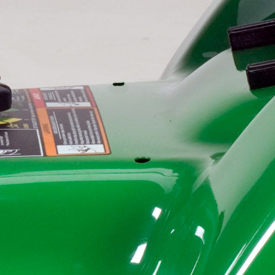 Exact Adjust access holes
Exact Adjust access holes
A mower deck must be level side-to-side and properly adjusted front-to-rear to give the best cutting performance. A removable onboard deck-leveling gauge and a hex-key tool are provided to make adjustment easy. They are securely stored under the tractor seat.
Exact Adjust leveling ports are provided on each side of the operator platform above the mower-level adjusting bolts. With the hex-shaped tool, they provide convenient access to allow quick and easy adjustment of the mower for the best-cut quality of cut.
The Exact Adjust feature is standard on all Select Series™ X300 and X500 Tractors:
- There is no need to reach under the fender deck while making the mower-level adjustment.
- Onboard deck-leveling gauge, Exact Adjust ports, and the hex tool work together.
- Level the mower deck side to side
- Set the correct amount of rake (front-to-back deck orientation)
- Calibrate the cutting height to the cut-height adjusting knob setting
- Exact Adjust simplifies leveling the mower deck if equipped with a Power Flow™ blower.
- To give the best cut, mower level should be adjusted if alternately mowing with and without blower installed. The Exact Adjust feature makes this easy.
 Deck-leveling tool placed under deck
Deck-leveling tool placed under deck
 Using included ball-hex tool to level mower deck
Using included ball-hex tool to level mower deck
Consult the operator's manual for the correct adjusting procedures for each tractor model. Basic adjusting steps to properly level the mower deck include:
- Park the tractor on a level surface.
- Inflate tires to the correct pressure.
- Consult the label for the cutting-height knob that is located on the console of the machine. This label shows deck-leveling position and location of deck-leveling adjustment points.
 Cut height adjusting knob
Cut height adjusting knob
- Set mower cutting-height knob to the correct deck-leveling position.
- For X300 models, use position 2.75
- For all other models, use position 2.5
- Adjust mower wheels as necessary so they do not contact the ground surface.
- Remove the onboard deck-leveling gauge that is located under the seat.
- Using the Exact Adjust ports and tool, adjust mower deck side-to-side level so the deck-leveling gauge just slips under the left and right lower deck rim at the designated adjustment points. The location of adjustment points will vary slightly between decks.
- Left- and right-rear adjustment points are under the deck rim near the rear mower wheels, if equipped.
- Adjust mower deck front-to-back level, if necessary.
- Loosen rear nuts equally on each side of front lift rod.
- Turn front nut equally on each side clockwise to raise front of mower or counterclockwise to lower it until gauge just slips under the front adjustment point.
- Tighten rear nuts after adjustment is complete.
- Return the gauge to its storage position.
NOTE: The adjusting tool supplied with the tractor is an 8-mm ball-hex key, part number M162737. The rounded end allows for some misalignment with the bolt as the deck is adjusted.
The MowerPlus™ app helps maintain the tractor and lawn
 MowerPlus app screen
MowerPlus app screen
 MowerPlus app maintenance screen
MowerPlus app maintenance screen
Keep a John Deere riding lawn mower running its best and know how it mows with the John Deere MowerPlus app. Simply scan the lawn tractor’s barcode to get custom information. The app helps determine the best time to mow, communicates expert pre-mow tips, offers maintenance reminders, and provides walk-through guides.
Look for the MowerPlus app on the mobile device’s app store.
The app supports residential lawn equipment such as 100 Series, S240, X300, X500, X700, Z200 through Z600, and many similarly-sized older products. It does not presently support tractor models numbered 1000 and larger, such as 1025R.
NOTE: Some product image variation may exist.
Also available is the John Deere MowerPlus smart connector (sold separately).
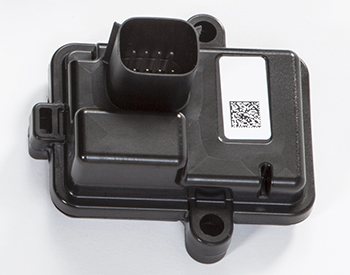 Smart connector
Smart connector
The John Deere MowerPlus smart connector wirelessly links a Select Series™ X300 or X500 Tractor to the MowerPlus app on a mobile device. The smart connector transmits engine usage to the app, making it easy to track maintenance intervals. It also transmits the fuel level to the app—when thinking ahead about Saturday morning mowing, the operator can make sure the tractor is fueled and ready to go.
Features
Heat-treated steel shank
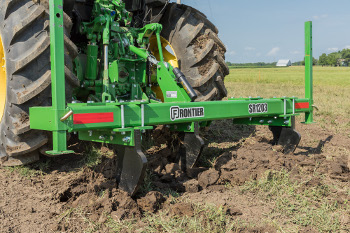 Heat-treated steel shank
Heat-treated steel shank
The Frontier™ SR12 Series Shank Rippers are equipped with a 61-cm (24-in.) heat-treated steel shank that fractures compacted hardpan to aid in root penetration and decrease water runoff.
Parking stand
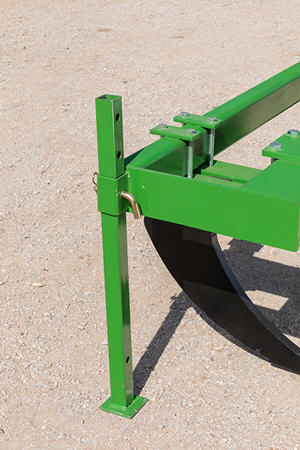 Parking stand
Parking stand
The SR12 Series Shank Rippers are equipped with a parking stand for ease of storing and attachability.
Replaceable shank point
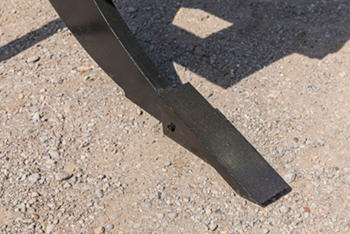 Replaceable shank point
Replaceable shank point
The SR12 Series Shank Ripper has a replaceable shank point, allowing for quick and easy maintenance and extending wear life and dependability.
Shear bolt protection
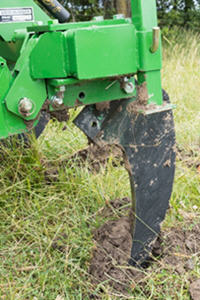 Shear bolt protection
Shear bolt protection
The Frontier™ SR12 Series Shank Ripper is equipped with shear pin shank protection to protect the implement and tractor when encountering obstacles.
Features
Cast-iron packer wheels for best performance
 Cast iron packer wheels with scraper kit
Cast iron packer wheels with scraper kit
The CP11 Series Cultipackers feature 24.1-cm (9.5-in.) cast-iron packer wheels for durable performance when breaking up dirt clods to create smooth, even seedbeds.
Park stands offer quick and easy storage
 Set park stands for quick storage
Set park stands for quick storage
Store the CP11 Series Cultipackers quickly and easily using the integrated park stands. Simply unclip the pin, drop the stands to the desired height, re-insert pin, unhook the implement, and move on to the next project.
 Park stands lifted
Park stands lifted
Scraper kit available for the toughest conditions
 Scraper kit mounted on cultipacker
Scraper kit mounted on cultipacker
Soil buildup should not get in the way of productivity. The optional scraper kit comes with individual scraper blades and brackets that quickly mount to the machine. The blades scrape off soil and trash buildup on the packer wheels to keep operators running smoothly while creating a smooth, even finish no matter the field condition.
| Option code | Attachment | Description |
| 905P | 5TLSKCP1148L |
Scraper kit for CP1148L |
| 905P | 5TLSKCP1172L | Scraper kit for CP1172L |
Durable square mainframe for optimum performance
 Square mainframe
Square mainframe
The durable square mainframe on the CP11 Series Cultipackers is built to bust the toughest clods.
Limited Category 1 Quick-Hitch for ease and time savings
 Limited Category 1 quick-hitch on CP11 Series
Limited Category 1 quick-hitch on CP11 Series
Get the time savings and easy hook-up of the Quick-Hitch standard with the CP11 Series Cultipackers. The CP11 Series Cultipackers are compatible with the limited Category 1 Quick-Hitch as the easiest way to save time when hooking and unhooking the machine.
Optional tongue and wheel kit for pull-type configuration
 30.5-cm (12-in.) diameter transport wheels included in the kit
30.5-cm (12-in.) diameter transport wheels included in the kit
 Clevis hitch and 4.8-cm (1 7/8-in.) ball hitch included in the kit
Clevis hitch and 4.8-cm (1 7/8-in.) ball hitch included in the kit
The CP11L Series Cultipackers can be converted from a 3-point implement to a pull-type implement with the optional tongue and wheel kit. The kit comes with two 30.5-cm (12-in.) diameter transport wheels and includes both a clevis hitch and a 4.8-cm (1 7/8-in.) ball hitch. This kit is for operators desiring a pull-type cultipacker for a 14.9-29.8 kW (20-40 hp) tractor. The kit is available for the CP1148L and CP1172L.
Features
Cast-iron packer wheels for best performance
 Cast iron packer wheels with scraper kit
Cast iron packer wheels with scraper kit
The CP11 Series Cultipackers feature 24.1-cm (9.5-in.) cast-iron packer wheels for durable performance when breaking up dirt clods to create smooth, even seedbeds.
Park stands offer quick and easy storage
 Set park stands for quick storage
Set park stands for quick storage
Store the CP11 Series Cultipackers quickly and easily using the integrated park stands. Simply unclip the pin, drop the stands to the desired height, re-insert pin, unhook the implement, and move on to the next project.
 Park stands lifted
Park stands lifted
Scraper kit available for the toughest conditions
 Scraper kit mounted on cultipacker
Scraper kit mounted on cultipacker
Soil buildup should not get in the way of productivity. The optional scraper kit comes with individual scraper blades and brackets that quickly mount to the machine. The blades scrape off soil and trash buildup on the packer wheels to keep operators running smoothly while creating a smooth, even finish no matter the field condition.
| Option code | Attachment | Description |
| 905P | 5TLSKCP1148L |
Scraper kit for CP1148L |
| 905P | 5TLSKCP1172L | Scraper kit for CP1172L |
Durable square mainframe for optimum performance
 Square mainframe
Square mainframe
The durable square mainframe on the CP11 Series Cultipackers is built to bust the toughest clods.
Limited Category 1 Quick-Hitch for ease and time savings
 Limited Category 1 quick-hitch on CP11 Series
Limited Category 1 quick-hitch on CP11 Series
Get the time savings and easy hook-up of the Quick-Hitch standard with the CP11 Series Cultipackers. The CP11 Series Cultipackers are compatible with the limited Category 1 Quick-Hitch as the easiest way to save time when hooking and unhooking the machine.
Optional tongue and wheel kit for pull-type configuration
 30.5-cm (12-in.) diameter transport wheels included in the kit
30.5-cm (12-in.) diameter transport wheels included in the kit
 Clevis hitch and 4.8-cm (1 7/8-in.) ball hitch included in the kit
Clevis hitch and 4.8-cm (1 7/8-in.) ball hitch included in the kit
The CP11L Series Cultipackers can be converted from a 3-point implement to a pull-type implement with the optional tongue and wheel kit. The kit comes with two 30.5-cm (12-in.) diameter transport wheels and includes both a clevis hitch and a 4.8-cm (1 7/8-in.) ball hitch. This kit is for operators desiring a pull-type cultipacker for a 14.9-29.8 kW (20-40 hp) tractor. The kit is available for the CP1148L and CP1172L.
Features
TruSet™ Tillage technology

The 2430 Chisel Plow is designed for precise, accurate depth control. Precise depth control is very important for conservation of moisture, fertilizer placement, and soil management. Soil layers of differing soil type vary across farms and even across fields. The ability to adjust for these conditions is extremely important to producers today.
TruSet and single-point depth control both come as standard equipment. Both provide accurate depth control to best utilize available tractor horsepower.
With TruSet, these adjustments can be done on the move, increasing productivity and making the day go easier for operators. TruSet provides accurate and precise depth control by the use of individual wheel sensors and electronic circuitry to perform tasks of leveling and depth measurements unprecedented in the industry until now. Accurate depth is displayed to the nearest 2.5 mm (1/10 in.).
The floating hitch, frame strength of the Tube-Thru-Tube manufacturing, and the wheel package placement allow the 2430 to offer unmatched consistency of depth (front-to-back and side-to-side). Fuel can be saved, soil can be mixed and shattered, and accurate depth can be maintained. This represents true soil management for the producer.
TruSet Side-to-Side
TruSet Side-to-Side gives producers the same level of individual section control that was available with AccuDepth™ hydraulics. However, there are differences in how the two systems are hydraulically plumbed.
The AccuDepth hydraulics required a correction valve on every frame section since the hydraulics were plumbed in parallel. The TruSet system is plumbed into a single-point (series) system.
The series hydraulics give producers the option of controlling depth with just the single-point depth control valve or individually controlling each frame section with a correction valve mounted at the base of each depth control cylinder on the wings. The individual section control with TruSet Side-to-Side is an upgrade to the base TruSet Tillage system.
TruSet Side-to-Side is controlled by five sensors compared to one sensor with the base TruSet Tillage system. With the five-sensor control, the implement can make depth control adjustments via sensor feedback on the wings.
TruSet Side-to-Side eliminates the need to rephase the depth control cylinders after several rounds in the field. However, it does require another step when calibrating.
Documentation and prescription
With integrated TruSet Tillage technology, operators can incorporate documentation and prescription functionality into their tillage operations. The tillage documentation feature will give producers the ability to capture and analyze the pass for additional coverage of the crop production cycle. Prescription functionality provides producers the capability to ensure their tillage operations are executed correctly, optimizing their investment in preparing for the next crop.
Operators can document data for the depth of their sweeps along with rolling basket down pressure. By creating an as-applied map based off of global positioning system (GPS) data for the job performed by each functional area on the implement, TruSet enables producers to document their tillage passes then later review and analyze the data for future agronomic decisions.
Additionally, the Prescription Creator by Agrian® company, a connected partner tool through the John Deere Operations Center, enables producers to create prescriptions for each functional area. Data from previous yields, soil surveys, or freehand drawing tools can be used to create prescriptions that will command the implement to the desired depth and pressure settings for optimum agronomic results.
Agrian is a trademark of Agrian, Inc.
Functionality by control option
| Single-point | TruSet | TruSet Side-to-Side | |
| One adjustment to change implement depth | X | X | X |
| Mechanical adjustment option | X | X | X |
| In-cab adjustment option | --- | X | X |
| In-cab individual section leveling | --- | --- | X |
| Tillage documentation and prescription | --- | X | X |
Radial tires

Radial tires reduce compaction points while operating in the field and minimize downtime caused by tire failures both in the field and during transportation. Radial mainframe tires now come in base equipment and can be an option on the wings. With a wider tire plate and lower inflation pressure, radial tires have a larger contact area with the ground to help minimize compaction.
Finishing components
The 2430 offers different rear attachment options to meet the unique agronomic needs of each producer. Producers have a choice of two rear attachments on the 2430 Chisel Plow.

Knife-edge hydraulic rolling basket with internal basket scraper
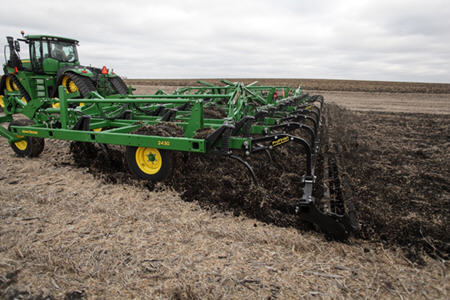 Knife-edge rolling basket for the 2430 Chisel Plow
Knife-edge rolling basket for the 2430 Chisel Plow
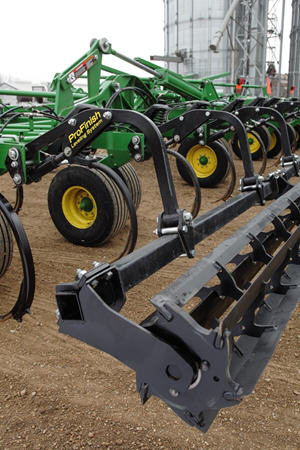 Internal Basket Scraper
Internal Basket Scraper
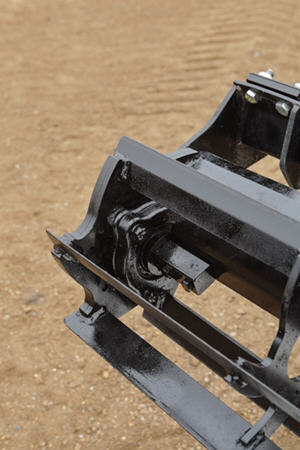
The knife-edge rolling basket for the 2430 Chisel Plow is made of hardened steel and handles rock strikes and adverse conditions well. The ease of down pressure adjustability allows the tool to adapt to changing field conditions. The internal basket scraper allows for a uniform field finish in wet conditions because baskets will not need to be raised out of the ground to avoid plugging; they can remain in the ground 100 percent of the time.
The John Deere 2430 Chisel Plow offers an active hydraulic rolling basket that gives the operator wide-ranging adjustability for a variety of conditions. The drawbars and rolling basket on the rear harrow are built with strength in mind for the demanding fall conditions. The system was designed to have the ability to run the rolling baskets in three different positions to finish and level the soil:
- Raised: allows the operator to raise the rolling baskets in harsh, muddy conditions
- Float: allows the operator to float the rolling baskets to lightly fluff soil
- Apply down pressure: allows the operator to adjust the basket pressure to provide consistent contact with the ground, provides a firm seedbed, and shatters root balls
The hydraulic rolling basket is offered with the knife-edge basket which is the best for heavier, wet soil.
240 Coil-Tine Chisel Plow Harrow
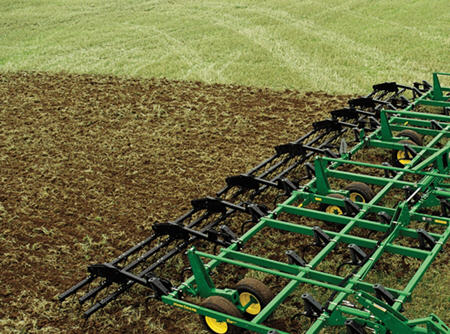 240 Coil-Tine Chisel Plow Harrow
240 Coil-Tine Chisel Plow Harrow
The 240 Coil-Tine Chisel Plow Harrow is designed specifically for the 2430 Chisel Plows. Harrow performance has grown increasingly important over the last few years as soil profile finish and residue-handling capability are on the top of the list for producers. Both of these attributes are standouts on this heavy harrow.
Variety of models and sizes available
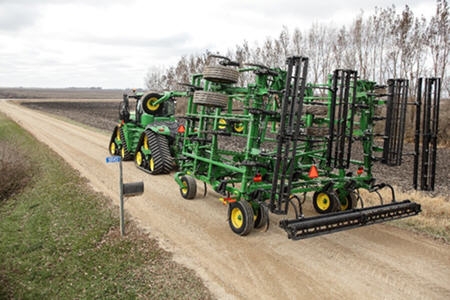 2430 Chisel Plow
2430 Chisel Plow
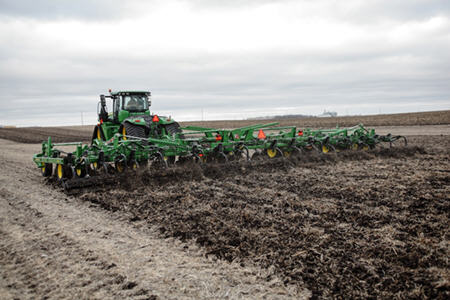 2430 Chisel Plow
2430 Chisel Plow
The 2430 Chisel Plow is available in rigid and rigid fold, three-section folding, and five-section folding frame models.
Models |
Type of fold |
Standards |
Rigid |
Non-fold or horizontal fold |
Spring reset, TruPosition™, or |
Flexible |
Three-section |
Spring reset, TruPosition, or |
Flexible |
Five-section |
TruPosition |
Rigid configurations |
||
| Working widths | Centerframe size | Transport width |
| 11 ft. 0 in. - 14 ft. 8 in. | 12 ft. non-folding | 11 ft. - 16 ft. |
| 14 ft. 0 in. - 17 ft. 8 in. | 15 ft. non-folding | |
| 17 ft. 6 in. - 21 ft. 0 in. | 12 ft. folding | |
| 3-section configurations | ||
| Working widths | Centerframe size | Centerframe size |
| 21 ft. 0 in. - 24 ft. 7 in. | 10 ft. | 15 ft. 9 in. |
| 25 ft. 0 in. - 28 ft. 8 in. | ||
| 23 ft. 1 in. - 25 ft. 9 in. | 12 ft. | 17 ft. 11 in. |
| 27 ft. 0 in. - 30 ft. 8 in. | ||
| 30 ft. 4 in. - 33 ft. 8 in. | ||
| 35 ft. 0 in. - 37 ft. 3 in. | ||
| 30 ft. 0 in. - 32 ft. 5 in. | 15 ft. | 20 ft. 11 in. |
| 34 ft. 2 in. - 38 ft. 2 in. | ||
| 40 ft. 0 in. - 42 ft. 3 in. | ||
| 5-section configurations | ||
| Working widths | Centerframe size | Centerframe size |
| 44 ft. 0 in. - 46 ft. 8 in. | 12 ft. | 17 ft. 4 in. |
| 46 ft. 9 in. - 50 ft. 0 in. | ||
| 52 ft. 0 in. - 54 ft. 8 in. | ||
| 46 ft. 11 in. - 49 ft. 10 in. | 15 ft. | 20 ft. 0 in. |
| 55 ft. 0 in. - 57 ft. 10 in. | ||
| 60 ft. 2 in. - 63 ft. 0 in. | ||
NOTE: Tru-Depth standards are available through 10 m (33 ft) only.
Excellent residue-handling capability
 2430 Chisel Plow
2430 Chisel Plow
The 2430 Chisel Plow has excellent residue-handling capability in primary tillage at all residue levels.
Typical percentages of residue cover remaining from the 2430 are listed in the following table. The percentages do not take into account variables such as the condition of the residue, speed, and soil type.
For machines with 305-mm (12-in.) spacing:
Starting |
Remaining non-fragile* |
Remaining fragile** |
||||||
406-mm (16-in.) sweeps |
51-mm x 356-mm (2-in. x 14-in.) chisel point |
102-mm x 368-mm (4-in. x 14.5-in.) shovel |
406-mm (16-in.) sweeps |
51-mm x 356-mm (2-in. x 14-in.) chisel point |
51-mm x 356-mm (2-in. x 14-in.) chisel point |
406-mm (16-in.) sweeps |
51-mm x 356-mm (2-in. x 14-in.) chisel point |
|
100 |
80 |
70 |
100 | 80 |
70 |
100 |
80 |
70 |
90 |
72 |
65 |
90 |
72 |
65 |
90 |
72 |
65 |
80 |
65 |
56 |
80 |
65 |
56 |
80 |
65 |
56 |
70 |
55 |
50 |
70 |
55 |
50 |
70 |
55 |
50 |
60 |
50 |
42 |
60 |
50 |
42 |
60 |
50 |
42 |
50 |
40 |
35 |
50 |
40 |
35 |
50 |
40 |
35 |
40 |
32 |
28 |
40 |
32 |
28 |
40 |
32 |
28 |
*Non-fragile residue includes crops like corn, sorghum, wheat (more than 45 bu).
**Fragile residue includes crops like soybeans, edible beans, peas, wheat (less than 45 bu), sunflower, peanuts, and cotton.
For machines with 406-mm (16-in.) spacing:
Starting |
Remaining non-fragile* |
Remaining fragile** |
||||||
457-mm (18-in.) sweeps |
51-mm x 356-mm (2-in. x 14-in.) chisel point |
102-mm x 368-mm (4-in. x 14.5-in.) shovel |
76-mm x 610-mm (3-in. x 24-in.) shovel |
457-mm (18-in.) sweeps |
51-mm x 356-mm (2-in. x 14-in.) chisel point | 102-mm x 368-mm (4-in. x 14.5-in.) shovel |
76-mm x 610-mm (3-in. x 24-in.) shovel | |
100 |
83 |
73 |
63 |
63 |
55 |
50 |
45 |
45 |
90 |
75 |
68 |
58 |
58 |
50 |
45 |
40 |
40 |
80 |
68 |
59 |
53 |
53 |
45 |
40 |
35 |
35 |
70 |
58 |
53 |
45 |
45 |
38 |
35 |
30 |
30 |
60 |
53 |
45 |
38 |
38 |
33 |
30 |
27 |
27 |
50 |
43 |
38 |
33 |
33 |
27 |
25 |
22 |
22 |
40 |
35 |
31 |
28 |
28 |
22 |
20 |
18 |
18 |
*Non-fragile residue includes crops like corn, sorghum, and wheat (more than 45 bu).
**Fragile residue includes crops like soybeans, edible beans, peas, wheat (under 45 bu), sunflower, peanuts, and cotton.
Proven frame construction
 3.4-m (11.17-ft) four-bar frame
3.4-m (11.17-ft) four-bar frame
Operators are requiring faster field working speeds, larger implements, and tractors because of a dramatic increase in farm size. The market is asking for and receiving tractors with more torque, more weight, and more horsepower.
Accommodating 600 engine horsepower tractors requires more from implement frame and hitch components, including thicker frame tubes, additional diagonal bracing, and frame gussets.
The frame is constructed of continuous 102-mm x 102-mm (4-in. x 4-in.) cross members inserted through 51-mm x 152-mm (2-in. x 6-in.), 76-mm x 152-mm (3-in. x 6-in.), and 102-mm x 152-mm (4-in. x 6-in.) fore-aft members. The mainframe boasts a structure made up of 102-mm x 152-mm (4-in. x 6-in.) fore-aft tubes.
The large frame member sizes, joint welds, and wheel module placement adds to the structural integrity, providing a stable front-to-rear and side-to-side operation.
Frame construction offers:
-
Consistent operating depth
- Level operation
- Restricts frame dip
Walk-Over wheels help provide consistent working depth
 Walk-Over wheels
Walk-Over wheels
Walk-Over wheels provide a consistent working depth in uneven ground for level seedbeds and complete weed control.
The staggered wheel design provides extra room for residue flow, obstacles, and transport stability.
Wide variety of ground-engaging tools available
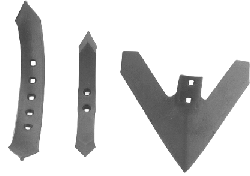 Shovels, chisels, and sweeps
Shovels, chisels, and sweeps

A wide variety of tools such as sweeps, chisels, and twisted shovels are available for the operator to maintain surface residue and ground profile under varying weather and soil conditions.
Click here to explore more about points, chisels, and sweeps.
Features
Wide range of working widths available to match acreage and power requirements
 Three-section configuration
Three-section configuration
 Five-section configuration
Five-section configuration
With working speeds up to 16.1 km/h (10 mph), the 2660VT can increase productivity and cover up to 24.2 ha (60 acres) per hour.
The 2660VT is available in sizes ranging from 6.68 m to 15.2 m (21 ft to 50 ft). Power requirements range from 24.5 to 34.25 kW/m (10 to 14 hp/ft) depending on the gang angle, soil, depth and speed. Multiple configurations enable producers to size their implement for their operation and agronomic needs.
Productivity:
| Three-section configurations | |
| Working width | Productivity per hour at 16.1 km/h (10 mph) |
| 6.68 m (21 ft, 9 in.) | 10.1 ha (25 acres) |
| 7.75 m (25 ft, 5 in.) | 12.55 ha (31 acres) |
| 9.2 m (30 ft, 3 in.) | 15 ha (37 acres) |
| 10.3 m (33 ft, 10 in.) | 16.6 ha (41 acres) |
| Five-section configurations | |
| Working width | Productivity per hour at 16.1 km/h (10 mph) |
| 13.3 m (43.5 ft) | 21.4 ha (53 acres) |
| 15.1 m (49.5 ft) | 24.3 ha (60 acres) |
Power requirements:
| Three-section configurations | |
| Working width | Power required (24.5-34.25 kW/m [10-14 engine hp/ft]) |
| 6.68 m (21 ft, 9 in.) | 149-208.8 kW (210-294 hp) |
| 7.75 m (25 ft, 5 in.) | 186.4-261 kW (250-350 hp) |
| 9.2 m (30 ft, 3 in.) | 223.7-313.2 kW (300-420 hp) |
| 10.3 m (33 ft, 10 in.) | 253.5-355 kW (340-476 hp) |
| Five-section configurations | |
| Working width | Power required (24.5-34.25 kW/m [10-14 engine hp/ft]) |
| 13.3 m (43 ft, 5 in.) | 320.7-449 kW (430-602 hp) |
| 15.1 m (49 ft, 5 in.) | 372.8-462.3+ kW (500-620+ hp) |
NOTE: Power requirement is dependent on field conditions, depth, and gang angle.
Versatility to adapt to changing field conditions with a 0- to 12-degree gang angle
 Adjustable gang angle
Adjustable gang angle
In the pursuit of a consistent field finish, producers are wanting a vertical tillage tool with great versatility in both the spring and the fall. For some producers, vertical tillage may mean a true 0-degree gang angle to leave more residue for highly erodible land. For others, it includes a more aggressive gang angle with greater horizontal soil movement to even out the field, fill in light ruts, remove weeds, or incorporate more residue.
To meet these ever-changing field conditions, the 2660VT has an adjustable gang angle from 0 degrees to 12 degrees.
This means that producers can adapt to both spring and fall fieldwork, as well as adjust to and match changing conditions within the same field or between different fields. Producers need to address multiple agronomic challenges like residue, weeds, and light ruts, and create an ideal seedbed even in changing field conditions. This range of gang angles allows operators to increase or decrease the gang angle to adapt to these challenges in the field.
Here are some examples of the capabilities of the 2660VT:
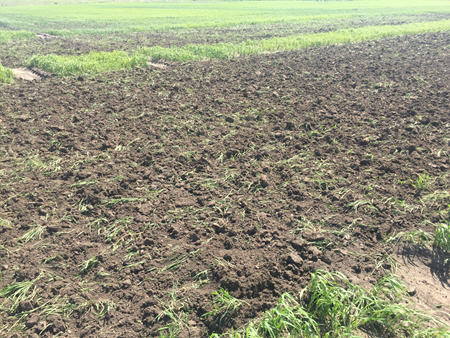 Light tire tracks
Light tire tracks
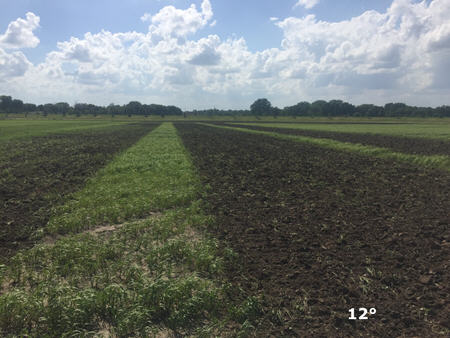 Weed removals
Weed removals
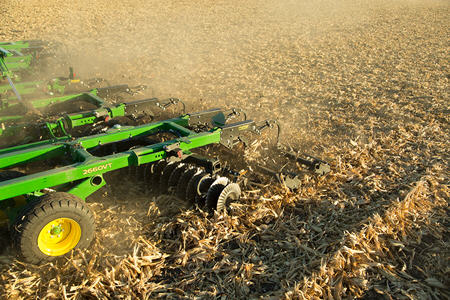 High residue
High residue
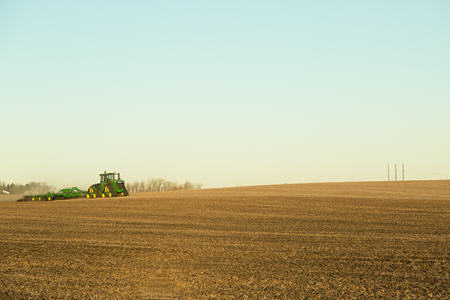 Highly erodible land
Highly erodible land
Quick and easy gang angle adjustments
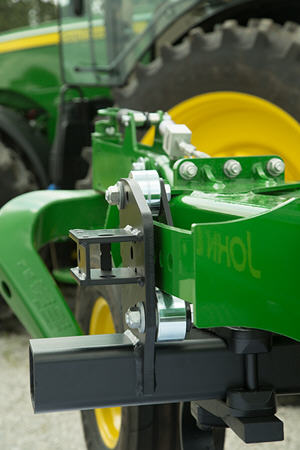 Adjust gang angle for field conditions
Adjust gang angle for field conditions
The 2660VT offers two different methods to adjust the gang angle to adapt to changing field conditions. With the TruSet™ system, the gang angle can be adjusted on the go from the cab, or it can be manually adjusted with the quick and easy-to-use gang roller slider.
Manual adjustment
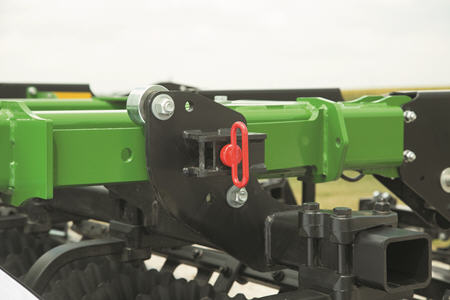 Manual adjustment of gang angle with spring-loaded pin
Manual adjustment of gang angle with spring-loaded pin
- Quick and easy-to-adjust
- Pull and lock open the spring-loaded pin, slide the gang to the new position, and lock it back in place
- Adjust gang angle in increments of two degrees (0, 2, 4, 6, 8, 10, and 12)
TruSet adjustment
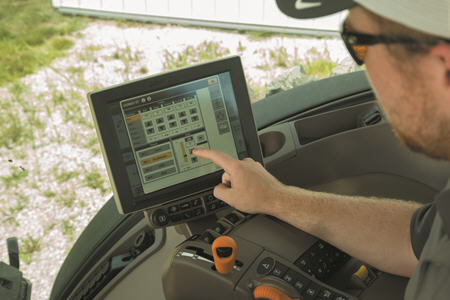 Adjust gang angle from cab with TruSet
Adjust gang angle from cab with TruSet
- Done with the push of a button on the display
- Adjust gang angle in increments of one degree (0, 1, 2, 3, 4, 5, 6, 7, 8, 9, 10, 11, and 12)
Below are the capabilities of the 2660VT with results from different gang angle settings:
Corn
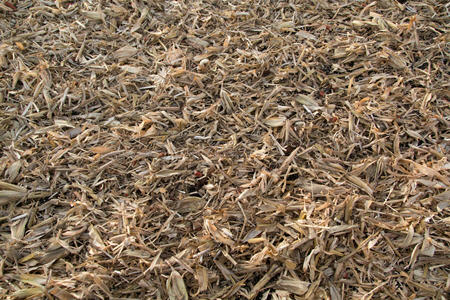 0-degree gang angle
0-degree gang angle
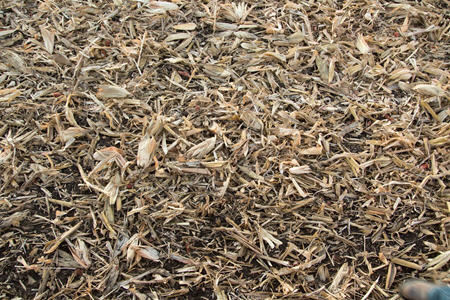 4-degree gang angle
4-degree gang angle
 8-degree gang angle
8-degree gang angle
 12-degree gang angle
12-degree gang angle
Soybeans
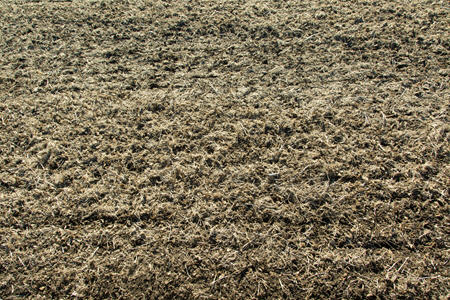 0-degree gang angle
0-degree gang angle
 4-degree gang angle
4-degree gang angle
 8-degree gang angle
8-degree gang angle
 12-degree gang angle
12-degree gang angle
Weeds
 2-degree gang angle
2-degree gang angle
 4-degree gang angle
4-degree gang angle
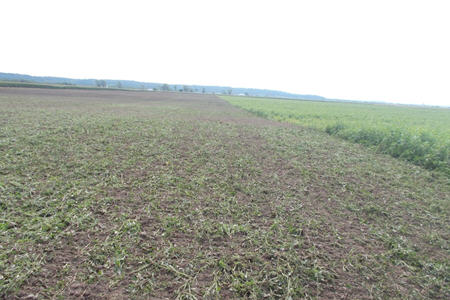 6-degree gang angle
6-degree gang angle
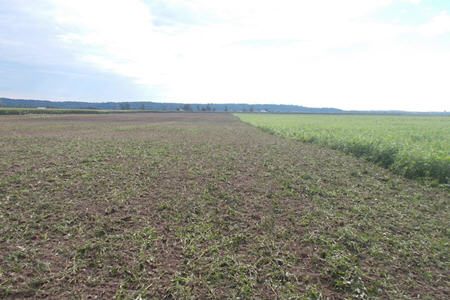 8-degree gang angle
8-degree gang angle
 10-degree gang angle
10-degree gang angle
 12-degree gang angle
12-degree gang angle
Vertical tillage agronomic challenges
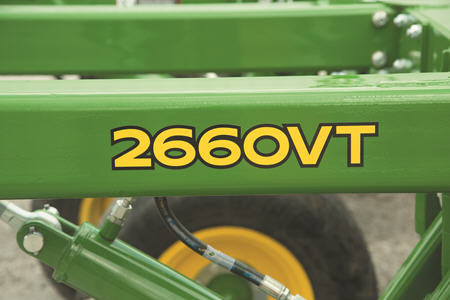 2660VT improves operator productivity
2660VT improves operator productivity
The 2660VT adjustable gang angle helps speed up soil warmup, so operators can get in the field to plant sooner.
It also levels the surface and sub-surface to ensure excellent planter ride quality and improves emergence that contributes to greater yields.
With the gang angle set at 0 degrees, operators get vertical soil movement and can chop, size, and pin residue.
Adjusting the gang angle from 1 to 12 degrees will provide more horizontal soil movement. The more aggressive the gang angle, the more soil mixing and burying of residue. Operators can remove light ruts, tracks, and weeds at the most aggressive gang angle.
Spring
 Spring tillage with the 2660VT
Spring tillage with the 2660VT
- Size and cut residue
- Break up surface crust layer
- Control weeds
- Dry/aerate and warm up the soil
- Improve seed-to-soil contact for uniform emergence
- Level and smooth surface
Fall
 Fall tillage with the 2660VT
Fall tillage with the 2660VT
- Cut, size, and bury residue
- Improve water infiltration
- Mix soil and residue for faster decomposition
- Level and distribute residue
- Incorporate nutrients or cover crops
- Fill in light tire tracks
Four stages of soil and residue processing
 Soil and residue processing with the 2660VT
Soil and residue processing with the 2660VT
Stage 1: Cutting and sizing
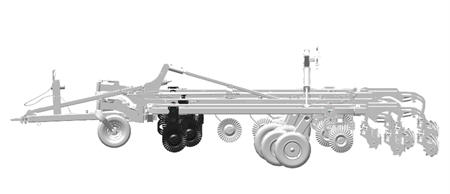 Adjustable front disk gang
Adjustable front disk gang
The 2660VT adjustable front disk gang is the beginning of the soil and residue mixing process. John Deere’s exclusive Commander ™ wavy blades with unique beveled angles easily penetrate the ground to fracture soil, generating tiny clods and starting the initial residue cutting, sizing, and chopping process.
To adapt to varying field conditions, the gang angle can easily be hydraulically adjusted from 0 degrees (true vertical tillage) to 12 degrees (aggressive mixing) on the go with TruSet™ Tillage system via a simple push of a button from the cab.
Stage 2: Distributing and mixing
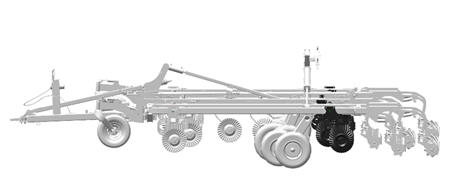 Adjustable rear gang
Adjustable rear gang
John Deere’s adjustable rear gang with Commander blades continues the mixing of loose soil and residue. The 2660VT rear gangs provide a consistent and uniform cut to maintain a shallow depth at higher working speeds.
The 2660VT’s slightly offset blade-follow-blade design allows for a more aggressive sub-surface soil blow out, where loose soil is lifted to the surface to be distributed and mixed in the following stages of the process. Slicing residue and placing it in contact with the soil hastens the degradation breakdown process.
Stage 3: Reconsolidation
 Knife-edge baskets
Knife-edge baskets
This exclusive John Deere ProFinish™ solution passively reconsolidates soil as it leaves the gangs, re-orientating it from parallel to perpendicular. The knife-edge basket in the reverse position keeps material in the soil profile, adding an additional step of processing to reduce clods and mix and pin residue, anchoring it to the surface.
The design levels the subsoil by perpendicularly knocking out larger ridges commonly seen behind competitive vertical tillage tools. This sub-surface interaction provides a smooth and uniform seedbed to optimize the planter ride quality in a variety of field and soil conditions.
Stage 4: Leveling
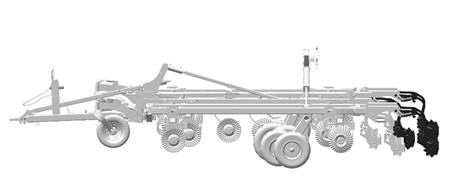 Hydraulic rolling baskets
Hydraulic rolling baskets
For further processing, this John Deere ProFinish solution pulverizes remaining clods, removes remaining soil from any worked root balls, and anchors remaining residue all while firming up the soil.
The hydraulically adjustable rolling basket helps distribute larger soil particles on the surface and finer soil particles in the seed zone to promote excellent seed-to-soil contact in the spring and to leave a level finish in the fall.
The dual hydraulic rolling baskets allow the operator to adjust down pressure, adapting to changing field conditions on the go and achieving the preferred final smooth and uniform field finish.
Exclusive Commander™ blade and extended-life bearings
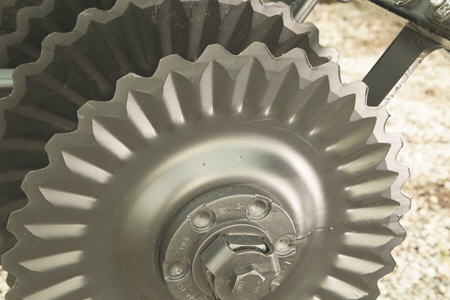 55.9-cm (22-in.) Commander blade with double-cut edge
55.9-cm (22-in.) Commander blade with double-cut edge
Exclusive to John Deere and designed specifically for the 2660VT, the Commander blade works across the entire gang angle range from 0 to 12 degrees. These low-draft, wavy straight blades on 18.41-cm (7.25-in.) spacing use a serrated edge to fracture and lift soil as well as cut and size residue.
The 55.9-cm (22-in.) wavy straight blade was designed with a double-cut edge which has specialized angled bevels to easily penetrate the ground, even in hard soil conditions. The straight wavy blade with shallow concavity leads to reduced blade compaction and less soil smearing than traditional smooth blades.
Adjusting the gang angle from 1 to 12 degrees will provide more horizontal soil movement. The more aggressive the gang angle, the more soil mixing and burying of residue.
Exclusive Commander blade
 Commander blade works in many soil conditions
Commander blade works in many soil conditions
The 55.9-cm (22-in.) Commander wavy straight blade is 6.5-mm (0.256-in.) thick, which allows operators to work in many different soil conditions. The blade is built to flex and absorb impacts in rocky conditions without bending, cracking, or breaking the blade for added durability.
Made of high-quality steel, the double-cut-edge Commander blade retains its sharp cutting edge due to the hardness on the outside surface, and it also ensures even wear life.
Extended-life bearings
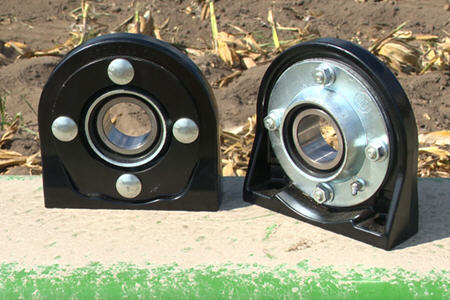 Extended-life bearings
Extended-life bearings
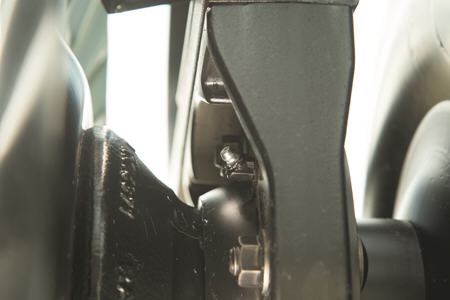 Bearings decrease stress on inner surfaces and minimize downtime
Bearings decrease stress on inner surfaces and minimize downtime
John Deere’s vertical tillage implements feature extended-life bearings. These more durable and reliable bearings allow producers to customize bearing maintenance for specific growing conditions and soil types.
The flange-mounted bearing and sealing system features improved contamination resistance. The advanced seal material is highly resistant to wear and damage caused by abrasive soils and other crop materials. The design of these are more durable and reliable than previous bearings.
The design of this bearing system allows for dynamic self-alignment to the gang bolt, as opposed to trunnion-mounted bearings that have limited alignment capability. The system features additional freedom of movement, accommodating a wider variety of field conditions. It has been designed to decrease stress and fatigue on the inner rolling surfaces, supporting extended bearing life.
The bearing and seal design allows for a limited, seasonal maintenance interval to minimize downtime. They also allow producers to customize maintenance for specific growing conditions and soil types. The multi-lipped sealing system cannot be damaged by frequent greasing. It allows bearings to accept grease within the bearing as well as provide grease to the outer bearing surface to eliminate wear between the bearing and housing. With this design, the bearings can accept grease even if misaligned to the housing.
ProFinish™ system hydraulic double rolling baskets provide a smooth and level field finish
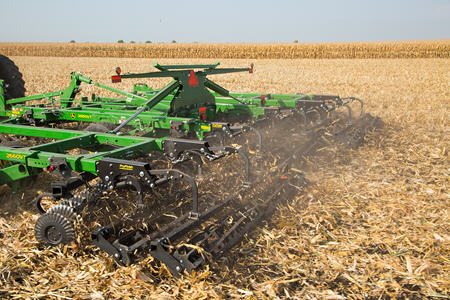 Hydraulic double rolling baskets
Hydraulic double rolling baskets
 Rolling baskets distribute residue and reduce clods
Rolling baskets distribute residue and reduce clods
John Deere’s ProFinish leveling system features a double rolling basket configuration as the solution for producers looking to flow high levels of residue and leave a smooth, level field finish. The front knife-edge basket in a reversed orientation allows the basket to passively keep soil and residue in the profile and adds an additional step that mixes, pins, and buries residue.
They help size clods and pin residue to reduce erosion in the fall, break down residue over the winter, and then leave a firm, smooth, and level seedbed finish in the spring.
The rear basket can be configured with either a flat bar or a round bar basket, depending on the producers’ agronomic needs. These baskets help distribute residue, reduce clods, and firm the soil to preserve moisture and level out the surface and sub-surface finish.
The drawbars and rolling baskets are built with strength in mind for demanding vertical tillage conditions. With these rolling baskets, a cast frame was designed to encase the bearing in a high-density polymer liner to allow dynamic movement and maintenance-free characteristics. The active hydraulic rolling basket features maintenance-free bearings to minimize non-productive activities.
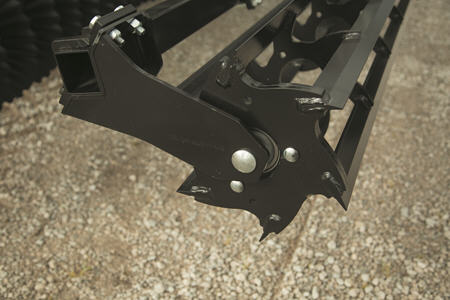 Cast frame and maintenance-free bearings on rolling baskets
Cast frame and maintenance-free bearings on rolling baskets
In order to change the rolling basket down pressure, simply rotate the down pressure valve dial clockwise to increase pressure and rotate it counterclockwise to decrease pressure.
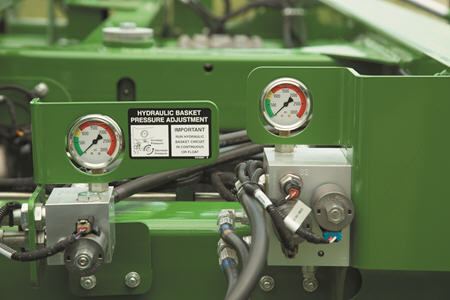 Rolling basket pressure adjustment
Rolling basket pressure adjustment
Fall conditions
 Incorporate soil and residue during fall tillage
Incorporate soil and residue during fall tillage
- Improve firming, mixing, and clod-shattering with double rolling baskets.
- Incorporate soil and residue and apply down pressure to shatter root balls.
- Decrease pressure to leave larger clods and a rougher field finish.
Spring
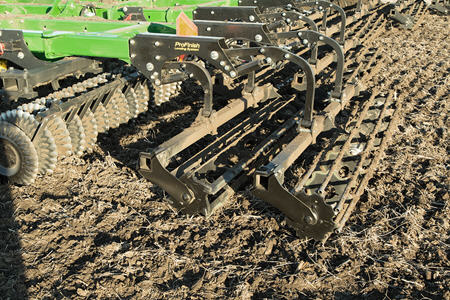 Distribute soil during spring tillage
Distribute soil during spring tillage
- Distribute larger soil particles on the surface and finer soil particles in the seed zone to promote excellent seed-to-soil contact. Yields can benefit when there is good soil adherence at germination for moisture and nutrient uptake, promoting early seedling growth.
- Soil particle size distribution also helps to deal with spring rains.
- Increase pressure to reduce clods and leave a firm soil seedbed to improve planter performance.
TruSet™ Tillage provides precise control from the cab on the go
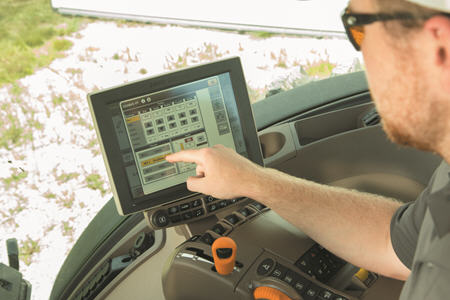 TruSet allows for adjustments from the cab
TruSet allows for adjustments from the cab
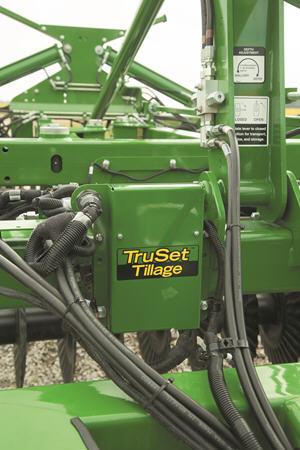 Adjust depth and down pressure with TruSet Tillage
Adjust depth and down pressure with TruSet Tillage
Integrated TruSet Tillage technology enables 2660VT operators to adjust depth and down pressure on the active hydraulic rolling baskets while on the go to respond to changing field conditions such as varying soils, heavier residue, and moisture.
TruSet depth and pressure control
 Adjust depth and pressure while in the field
Adjust depth and pressure while in the field
With short windows of time to perform tillage operations, TruSet can provide significant productivity improvements as operators are able to adjust the 2660VT while covering acres with the push of a button. By responding to conditions as they change throughout the field, TruSet enables operators to generate better-quality tillage performance with the first pass.
Using a GreenStar™ display, an operator sees real-time data for depth and basket down pressure for assurance of desired tillage outcomes. Operators are able to make independent adjustments as small as 2.54 mm (1/10 in.). Four customizable presets enable operators to save and name different combinations of settings for their most common field conditions, which allows for even quicker implement adjustments.
Single-point depth control is included with the TruSet Tillage system, giving operators the choice of automated or manual adjustments. Hydraulic routings on the 2660VT are designed to allow each implement to feature both TruSet and standard single-point depth control for system redundancy, operator preference, and flexibility at resale.
With the 2660VT, John Deere has expanded TruSet to bring even more functionality into the cab:
- Depth and rolling basket down pressure
- Gang angle
- Hydraulic active stabilizer wheels
- Hydraulic wing control
- Hydraulic fore/aft control
TruSet gang angle control
 Gang angle adjustment on the 2660VT
Gang angle adjustment on the 2660VT
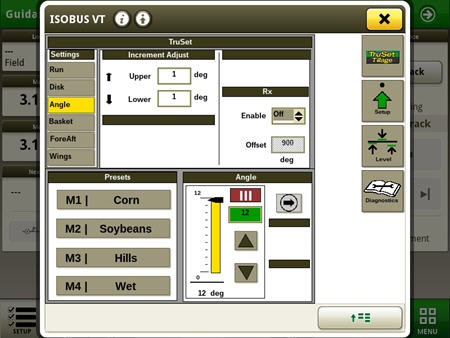 Adjust the gang angle from the in-cab display
Adjust the gang angle from the in-cab display
With TruSet gang angle control, operators are able to adjust the gang angle on the go right from the cab.
Adjusting the gang angle from 1 to 12 degrees will provide more horizontal soil movement. The more aggressive the gang angle, the more soil mixing and burying of residue. Operators can also remove light ruts, tracks, and weeds at the most aggressive gang angle.
TruSet Side-to-Side leveling
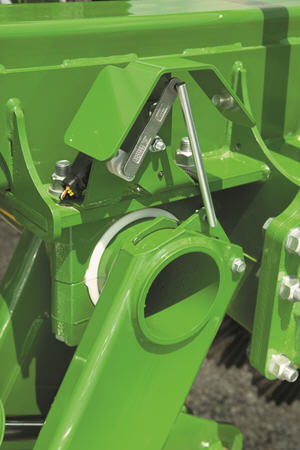 Individual section leveling with TruSet
Individual section leveling with TruSet
2660VT operators have the option to enhance the TruSet Tillage system with individual section leveling functionality. TruSet Side-to-Side gives operators individual section control to independently adjust the depth of the centerframe and wing frames for even more accurate depth control.
TruSet Side-to-Side is available from the factory or as an upgrade with a field conversion kit.
TruSet active hydraulic stabilizer wheels
 Hydraulic cylinder for stabilizer wheels
Hydraulic cylinder for stabilizer wheels
Getting the best field performance is easier with TruSet active hydraulic stabilizer wheels. Choose TruSet stabilizer wheels as an option on the 2660VT to easily adjust the depth of the stabilizer wheels from the cab to match the overall depth as changes are made on the 2660VT. This feature replaces the mechanical linkage on stabilizers wheels with a hydraulic cylinder.
TruSet hydraulic wing control
 Hydraulic wing control pressure
Hydraulic wing control pressure
TruSet hydraulic wing control is available as optional equipment on all three-section 2660VT implements. This feature transfers the weight from the mainframe to the wings to improve penetration in hard or heavy soils. In high-speed, shallow-depth tillage operations, maintaining a consistent depth across the tillage tool is critical to the consistency of the seedbed.
TruSet fore/aft control
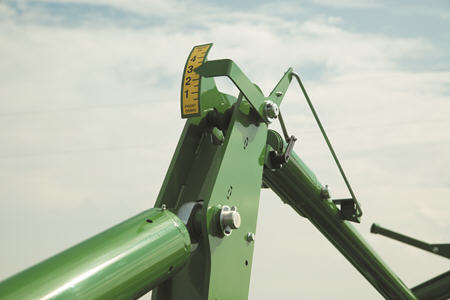 Hydraulic fore/aft control levels the 2660VT
Hydraulic fore/aft control levels the 2660VT
The TruSet hydraulic fore/aft control option enables operators to level the 2660VT from the comfort of the tractor cab.
Tillage documentation and prescription functionality included with TruSet™ Tillage
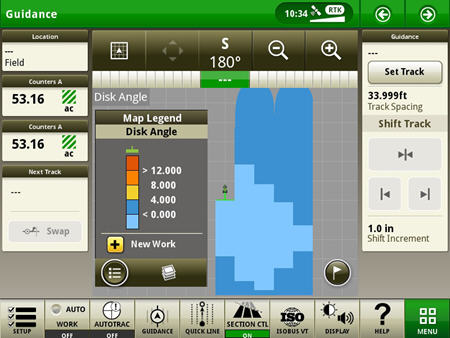 Document gang angle and other data to analyze
Document gang angle and other data to analyze
With integrated TruSet Tillage technology, 2660VT operators can incorporate documentation and prescription functionality into their tillage operations. The tillage documentation feature will give producers the ability to capture and analyze the vertical tillage pass for additional coverage of the crop production cycle. Prescription functionality provides producers the capability to ensure their tillage operations are executed correctly, optimizing their investment in preparing for the next crop.
Operators can document data for the depth of their vertical tillage, gang angle, and rolling basket down pressure. By creating an as-applied map based off of global positioning system (GPS) data for the job performed by each functional area on the implement, TruSet enables producers to document their tillage passes then later review and analyze the data for future agronomic decisions.
Prescriptions provide even more automation for the 2660VT. For example, operators can create a zone in higher yielding areas to increase the gang angle to chop, size, mix, and bury more residue. On hills, operators can create zones to reduce the gang angle to keep more soil intact to prevent erosion.
Additionally, the Prescription Creator by Agrian® company, a connected partner tool through the John Deere Operations Center, enables producers to create prescriptions for each functional area on the 2660VT. Data from previous yields, soil surveys, or freehand drawing tools can be used to create prescriptions that will command the implement to the desired depth and pressure settings for optimum agronomic results.
Agrian is a trademark of Agrian, Inc.
Compact transport dimensions
Producers are increasing the size of their operations and adding miles of transport to their day. To accommodate those changing demands, the 2660VT is designed with tight and narrow dimensions for easy transportability.
Low power lines and narrow roads and bridges can be a concern when transporting equipment. The 2660VT has a compact transport design that minimizes transport height and width to provide some of the best transport dimensions in the industry.
| Transport dimensions | ||||||
| Three-section | Five-section | |||||
| Working width* | 6.68 m (21 ft. 9 in.) | 7.7 m (25 ft. 5 in.) | 9.2 m (30 ft. 3 in.) | 10.3 m (33 ft. 10 in.) | 13.3 m (43 ft. 6 in.) | 15.1 m (49 ft. 6 in.) |
| Transport width | 4.3 m (14 ft. 3 in.) | 4 m (13 ft. 2 in.) | 4.7 m (15 ft. 7 in.) | 5.3 m (17 ft. 6 in.) | 4.6 m (15 ft. 3 in.) | 4.6 m (15 ft. 3 in.) |
| Transport height | 3.3 m (10 ft. 8 in.) | 3.8 m (12 ft. 5 in.) | 4.3 m (14 ft. 3 in.) | 4.3 m (14 ft. 3 in.) | 3.9 m (12 ft. 10 in.) | 4.3 m (14 ft. 3 in.) |
| Underframe clearance | 0.3 m (12 in.) | |||||
| Transport length** | 10.1 m (33 ft.) | 11.9 m (39 ft.) | ||||
*When gang angle is adjusted to 0 degrees
**Without rear hitch
Light-emitting diode (LED) lights
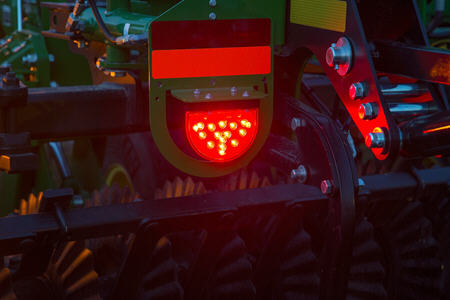 LED service light during night operation
LED service light during night operation
 LED service light
LED service light
LED service lights are standard on all 2660VT configurations.
Soil shield
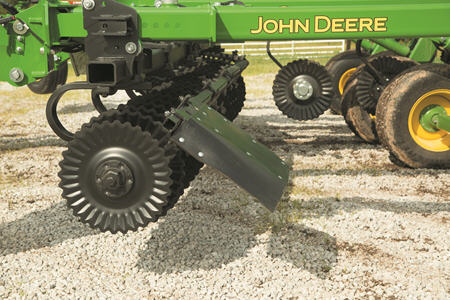 Soil shield keeps soil in the profile
Soil shield keeps soil in the profile
Increase productivity and get a true working width with every pass with the full-width 2660VT. No overlap is required with the soil shield equipped on the 2660VT. The soil shield is designed to keep soil and residue in the profile at more aggressive gang angles. Reduce passes through the field and cover more acres per hour all while decreasing fuel usage.
Hydraulic wing down pressure
 Adjust hydraulic pressure to wing-fold cylinders to improve soil penetration
Adjust hydraulic pressure to wing-fold cylinders to improve soil penetration
Hydraulic wing control is available as optional equipment on all three-section 2660VT models. This feature allows for varying hydraulic pressure to the wing-fold cylinders, which transfers weight from the mainframe to the wings to improve penetration in hard ground or heavy soils.
Maintaining consistency across the entire width of the tillage tool is crucial to the final field finish. Hydraulic wing control stabilizes the wings at shallow depths and high speeds. To fine-tune down pressure, a valve is conveniently located at the front of the implement to adjust the down pressure.
To make this adjustment in the cab, TruSet™ hydraulic wing control is another option that can be configured on three-section implements.
Features
A versatile sprayer to increase performance and reduce cost
Choose between 946.4-L or 1135.6-L (250-gal. or 300-gal.) tank
 946.4-L (250-gal.) tank shown
946.4-L (250-gal.) tank shown
Choose which tank size best fits the area needing sprayed and the producer’s current tractor.
Choose between hydraulic or power take-off (PTO) pump
 Hydraulics for pump
Hydraulics for pump
The hydraulic 75-204 pump comes standard on the LS1145 model and has a 102.2-L/min (27-gpm) flow. There is also an option to choose a hydraulic 150-206 pump with the LS1145.
 PTO pump shown
PTO pump shown
The six-roller PTO pump has a 79.5-L (21-gpm) flow and comes standard on the LS1125, LS1130, LS1130BL, and LS1140.
Choose between single nozzle body or triple nozzle body on 12.2-m (40-ft) boom
 Single nozzle body
Single nozzle body
 Triple nozzle body
Triple nozzle body
Single nozzle bodies come standard on all units. Producers can upgrade to a triple nozzle body for increased accuracy and the ability to quickly change between chemicals.
Booms built to help reduce repair costs
 Manual fold/unfold on LS1130
Manual fold/unfold on LS1130
 Hydraulic fold/unfold on LS1145
Hydraulic fold/unfold on LS1145
All models, except the LS1145, fold and unfold manually. Simply remove a pin and swing the arms out, then extend the outermost edge of the boom. The LS1145 hydraulically folds and unfolds, allowing the operator to stay in the cab.
Breakaway booms
 Hinge on boom
Hinge on boom
The boom has a hinge that allows it to break away instead of damaging crucial components when inadvertently hitting an obstacle.
Wet booms
The boom utilizes a stainless-steel pipe, instead of multiple hoses, for product distribution. This configuration leads to fewer parts, less chance of product trapped in the lines, and a reduced pressure drop.
Gas cylinder on manual-fold booms
The gas cylinder provides an ergonomic and safe mechanism that shortens manual folding and unfolding time.
Consistent and accurate placement of chemical
Raven® SCS 440™ Controller
 Raven SCS440 Controller
Raven SCS440 Controller
The Raven SCS 440 Controller automatically controls up to five sections (including two fenceline nozzles) of the boom depending on the speed of the tractor.
Texas Industrial Remcor console
 Texas Industrial Remcor console
Texas Industrial Remcor console
The Texas Industrial Remcor console manually controls three separate sections of the boom.
Foam markers
 Foam marker
Foam marker
 Foam marker solution tank
Foam marker solution tank
Prevent crop damage and inability to control weeds due to skips and overlap by visualizing the placement of chemicals with foam markers.
SCS 440 is a trademark of Raven Industries Incorporated.
Designed for quick hook up, movement, or loading of sprayer
 Fork pockets on stand
Fork pockets on stand
The sprayer has an integrated parking stand and fork pockets to make hook up and movement of the sprayer quick and easy. It is Category 2 and 3 quick-hitch compatible.
Teardrop-shaped tank allows for quick clean up
 Teardrop-shaped tank
Teardrop-shaped tank
The shape of the tank allows the liquid inside the tank to completely drain out, making it faster to switch from one chemical to the next, or prepare for storage.
Spray wand included to reach stubborn weeds
 Spray wand as standard equipment
Spray wand as standard equipment
All models in the LS11 Series Sprayers include a hand-held spray wand with a 9.14-m (30-ft) hose as standard equipment.
Features
Market-leading narrow transport width provides superior productivity
 2530L Liquid Applicator in transport
2530L Liquid Applicator in transport
 Narrow transport width improves productivity
Narrow transport width improves productivity
Simplify time-consuming transport logistics by easily moving from field to field in the 2530L Liquid Applicator, regardless of road size or quality. Easier machine movement enhances the daily acreage potential which is a critical need in tight application windows, delivering greater operator productivity. Logistical challenges with narrow roadways and bridges are also reduced with these compact transport dimensions.
This innovative toolbar design has a transport width of 3.6 m (11 ft, 10 in.) with optional hydraulically controlled gauge wheels. This folding geometry allows for the reduced transport width. The hydraulic gauge wheels are tied into the hydraulic folding circuit.
 Folding geometry of the 2530L
Folding geometry of the 2530L
Various sizes and configurations available to fit the right machine to any size operation


The John Deere 2530L offers two larger configurations to fit any size operation, with working widths of 18.3 m (60 ft) or 20.1 m (66 ft) and side-fold function. The 2530L comes with either a 6814-L or 9842-L (1800-gal. or 2600-gal.) tank and has a working speed ranging from 8-12.9 km/h (5-8 mph). This speed ensures high productivity with low residue disturbances and accurate placement with effective sealing.
| Code | Description |
| 7001XF | 2530L NT – 6814-L (1800-gal.) side-fold liquid applicator |
| 7002XF | 2530L NT – 9842-L (2600-gal.) side-fold liquid applicator |
There are eight different spacing options available on the 2530L, providing operators with a 17- to 49-row application. This versatility allows for machine customization to meet the operator’s needs.
| Code | Description |
| 5289 | 23 coulters on 76.2-cm (30-in.) spacing |
| 5291 | 25 coulters on 76.2-cm (30-in.) spacing |
| 529D | 47 coulters on 38.1-cm (15-in.) spacing |
| 529E | 49 coulters on 38.1-cm (15-in.) spacing |
| 5292 | 35 coulters on 50.8-cm (20-in.) spacing |
| 5294 | 37 coulters on 50.8-cm (20-in.) spacing |
| 5293 | 35 coulters on 55.9-cm (22-in.) spacing |
| 5295 | 37 coulters on 50.8-cm (20-in.) spacing |
| 529F | 17 coulters on 91.4-cm (36-in.) spacing |
| 529G | 19 coulters on 91.4-cm (36-in.) spacing |
| 529H | 17 coulters on 96.5-cm (38-in.) spacing |
| 529J | 19 coulters on 96.5-cm (38-in.) spacing |
| 529C | 17 coulters on 101.6-cm (40-in.) spacing |
| 529K | 19 coulters on 101.6-cm (40-in.) spacing |
Low-profile compact stealth tank improves machine stability
 Low-profile stealth tank
Low-profile stealth tank
The low-profile stealth tank of the 2530L offers both 6814-L and 9842-L (1800-gal. and 2600-gal.) capacities with more even weight distribution on the trailer. The low-profile design gives the operator even more visibility from the cab. The compact design also allows the toolbar to fold over the top of the tank, providing the narrow transport dimensions.
This industry-exclusive tank design gives the operator increased productivity and versatility. This patented tank offers:
- Low center of gravity for increased stability
- Large trough-sloped sump for maximum cleanout
- Unique design that allows for operating in various row spacing from 38.1 cm to 101.6 cm (15 in. to 40 in.) depending on coulter spacing, tires, and wheels selection
Tank capacity
The large tank capacities and quick cleanout allows the operator to spend more time in the field and less time rinsing.
| Model | 2530L NT Side-Folding Liquid Applicator |
| Tank sizes | 6814 L (1800 gal.) |
| 9842 L (2600 gal.) |
Tank fill
 7.62-cm (3-in.) tank fill
7.62-cm (3-in.) tank fill
In order to reduce filling time, the 2530L offers a 7.62-cm (3-in.) fill on 6814-L and 9842-L (1800-gal. and 2600-gal.) tanks.
Premium John Deere solution system with GreenStar™ Rate Controller
 Rate controller on 2530L
Rate controller on 2530L
 Gen 4 Display
Gen 4 Display
The 2530L comes standard with a GreenStar Rate Controller enabling full one-step integration of the GreenStar Display with the 2530L liquid system. This integration enables:
- Automatic rate control
- Field documentation
- Map-based prescriptions
- John Deere Section Control*
*NOTE: John Deere Section Control activation required.
System pressure is monitored directly on the GreenStar Display for easy adjustment as well as a secondary standard visual gauge for initial setup or troubleshooting.
John Deere Section Control reduces overlap, thus lowering input costs. The John Deere 2530L has up to five sections of control depending on size and configuration of the machine.
The Premium John Deere solution system consists of the following components:
- Five-section valve stack
- KZCO actuators
- Rate control valve
- Flowmeter
- Hypro® 9036 pump
- GreenStar Rate Controller
Hypro is a trademark of Pentair Flow Technologies, LLC.
Dual-wing hydraulic down pressure and flex-hinge design ensures accurate fertilizer placement
 2530L Side-Fold in the field
2530L Side-Fold in the field
Accurate fertilizer application is vital to increase fertilizer efficiency and effectiveness, which will help a producer reach their yield goals. In addition to mainframe down pressure, the 2530L offers dual-wing hydraulic down pressure in base and a flex-hinged design that ensures accurate fertilizer placement by keeping all coulters in the ground. This hydraulic down pressure will give the coulters even better ground penetration for harder soil conditions, providing a more consistent application.
There is an option for additional hydraulic down pressure on the outer flip wings, providing the same consistency and quality of application in uneven ground conditions.
| Code | Description |
| 5170 | Locking outer wing tip |
| 5171 | Hydraulic down pressure on outer wing tip |
Hydraulic wing down pressure
 Hydraulic wing down pressure gauge
Hydraulic wing down pressure gauge
The 2530L features hydraulic wing down pressure that applies constant down pressure on the wings to maintain constant depth and application. With up to 4.14 bar (600 psi), it maintains a consistent depth for accurate fertilizer placement.
Flex-wing hinge design
 2530L Side-Fold flex hinge
2530L Side-Fold flex hinge
All 2530L Liquid Applicators are designed to have flex for much better ground penetration and even depth control in uneven terrain. This design allows for below-level travel on the toolbar, which ensures the coulter is always in contact with the ground for the most accurate fertilizer placement.
The flex hinge allows for 15-degree below-level and 10-degree above-level travel:
- Ensures constant contact with the ground
- Increases performance in uneven terrain
- Maintains even working depth across the entire working width
- Provides accurate fertilizer placement
Utilize hydraulic wing kick and high-clearance toolbar frame to reduce crop damage
 2530L using wing kick
2530L using wing kick
When using side-dress application, an operator’s ability to minimize crop damage during application is paramount. The 2530L comes in base with features such as hydraulic wing kick, single-reach tongue, and higher operating clearances that allow operators to reduce that damage and expand that application window.
Hydraulic wing kick
Hydraulic wing kick is a key feature that helps reduce crop damage. No more dipping into the crop and damaging corn when turning. When the operator lifts the toolbar during the turn, the wings will automatically kick up in order to increase its distance from ground to toolbar. This action allows the operator to have increased clearance on the wings, minimizing crop damage.
Single-reach tongue
 2510L tongue
2510L tongue
Unlike some fertilizer applicators with an A-frame tongue, the 2530L features a single-reach tongue that is a single tube from the main cart frame to the hitch point. This allows:
- Sharper turning radius
- Reduced crop damage
- Better tractor to implement tracking
Operating toolbar frame clearance
 2530L frame clearance
2530L frame clearance
A 74.9-cm (29.5-in.) operating clearance allows the operator to maneuver in the field while minimizing crop damage.
Heavy-duty Accurate Placement (AP) coulter

The heavy-duty 50.8-cm (20-in.) AP coulter is made of three castings designed for long-term durability. This coulter ensures that nitrogen is placed in the ground at a consistent depth. It also provides greater flexibility in adjusting and attaching the coulter to the toolbar. The AP coulter features a hardened hex shaft that can easily be adjusted for 7.6-cm (3-in.) or 12.7-cm (5-in.) offsets. There are two options, the knife coulter or injector coulter, depending on soil conditions.
AP coulters slice through residue instead of dragging it or moving it out of the way.
Knife coulter
 Knife coulter
Knife coulter
The knife coulter is recommended in non-rocky soil conditions. This option allows for the most efficient application of fertilizer by knifing directly into the soil.
Injector coulter
 Injector coulter
Injector coulter
The injector coulter is recommended in rocky soil conditions. The injector is stainless steel and features non-drip tips that produce constant solid streams up to 45.7-cm (18-in.) long.
Features
Variety of models and sizes available
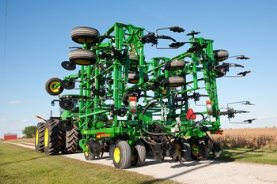 2430C Nutrient Applicator
2430C Nutrient Applicator
The 2430C Nutrient Applicator is available in five machine configurations:
- 19 row – 3.66-m (12-ft) centerframe, 5-section, 305-mm (30-in.) spacing
- 21 row – 4.57-m (15-ft) centerframe, 5-section, 305-mm (30-in.) spacing
- 23 row – 4.57-m (15-ft) centerframe, 5-section, 305-mm (30-in.) spacing
- 24 row – 4.57-m (15-ft) centerframe, 5-section, 305-mm (30-in.) spacing
- 25 row – 4.57-m (15-ft) centerframe, 5-section, 305-mm (30-in.) spacing
Size |
Working width |
Transport width |
Transport height |
19 row |
14.5 m (47 ft, 6 in.) |
6.0 m (19 ft, 8 in.) |
4.30 m (14 ft, 1 in.) |
21 row |
16.0 m (52 ft, 6 in.) |
6.60 m (21 ft, 8 in.) |
4.70 m (15 ft, 5 in.) |
23 row |
17.5 m (57 ft, 6 in.) |
6.60 m (21 ft, 8 in.) |
5.0 m (16 ft, 5 in.) |
24 row |
18.3 m (60 ft) |
6.60 m (21 ft, 8 in.) |
5.0 m (16 ft, 5 in.) |
25 row |
19.1 m (62 ft, 6 in.) |
6.60 m (21 ft, 8 in.) |
5.0 m (16 ft, 5 in.) |
The five individual frame sections can be adjusted independently of each other. The operator can tailor the depth setting of individual sections to ensure proper product sealing and fertilizer placement even in compressed wheel track areas and varying field conditions.
TruSet™ Tillage technology
The 2430C Nutrient Applicator is designed for accurate nutrient placement. Precise depth control is very important for conservation of moisture, fertilizer placement, and soil management. Soil layers of differing soil type vary across farms and even across fields. The ability to adjust for these conditions is extremely important to producers today.
TruSet and single-point depth control both come as standard equipment. Both provide accurate depth control to best utilize available tractor horsepower.
With TruSet, these adjustments can be done on the move, increasing productivity and making the day go easier for operators. TruSet provides accurate and precise depth control by the use of individual wheel sensors and electronic circuitry to perform tasks of leveling and depth measurements unprecedented in the industry until now. Accurate depth is displayed to the nearest 2.5 mm (1/10 in.).
The field-proven single-point depth control offers the producer one easy, front-mounted crank to dial in their depth control for the entire implement. From one location, this adjustment is easily and quickly completed.
The floating hitch, frame strength of the Tube-Thru-Tube manufacturing, and the wheel package placement allow the 2430C to offer unmatched consistency of depth (front-to-back and side-to-side). Fuel can be saved, soil can be mixed and shattered, and accurate depth for nutrients can be maintained. This represents true soil management for the producer.
TruSet Side-to-Side
TruSet Side-to-Side gives producers the same level of individual section control that was available with AccuDepth™ hydraulics. However, there are differences in how the two systems are hydraulically plumbed.
The AccuDepth hydraulics required a correction valve on every frame section since the hydraulics were plumbed in parallel. The TruSet system is plumbed into a single-point (series) system.
The series hydraulics give producers the option of controlling depth with just the single-point depth control valve or individually controlling each frame section with a correction valve mounted at the base of each depth control cylinder on the wings. The individual section control with TruSet Side-to-Side is an upgrade to the base TruSet Tillage system, allowing even more accurate nutrient placement.
TruSet Side-to-Side is controlled by five sensors compared to one sensor with the base TruSet Tillage system. With the five-sensor control, the implement can make depth control adjustments via sensor feedback on the wings.
TruSet Side-to-Side eliminates the need to rephase the depth control cylinders after several rounds in the field. However, it does require another step when calibrating.
Documentation and prescription
With integrated TruSet Tillage technology, operators can incorporate documentation and prescription functionality into their tillage operations. The tillage documentation feature will give producers the ability to capture and analyze the pass for additional coverage of the crop production cycle. Prescription functionality provides producers the capability to ensure their tillage operations are executed correctly, optimizing their investment in preparing for the next crop.
Operators can document data by creating an as-applied map based off of global positioning system (GPS) data for the job performed by the implement. TruSet enables producers to document their tillage passes then later review and analyze the data for future agronomic decisions.
Additionally, the Prescription Creator by Agrian® company, a connected partner tool through the John Deere Operations Center, enables producers to create prescriptions for each functional area. Data from previous yields, soil surveys, or freehand drawing tools can be used to create prescriptions that will command the implement to the desired depth and pressure settings for optimum agronomic results.
Agrian is a trademark of Agrian, Inc.
Functionality by control option
| Single-point | TruSet | TruSet Side-to-Side | |
| One adjustment to change implement depth | X | X | X |
| Mechanical adjustment option | X | X | X |
| In-cab adjustment option | --- | X | X |
| In-cab individual section leveling | --- | --- | X |
| Tillage documentation and prescription | --- | X | X |
Rear hitch
The ability to tow an anhydrous tank is an important component of anhydrous applications. The 2430C is equipped with a rear hitch capable of towing up to 11364 kg (25000 lb).
Tank hookup is made easier by extending the drawbar outwards and side-to-side laterally. It is constructed of heavy-duty tubing to ensure reliability and withstands higher towing capacity demands.
Improved rear hitch design
An improved rear hitch design enables operators to utilize tow-behind attachments such as an additional leveling attachment or field finishing tool. Side-to-side range is improved by 56 percent.
Adjustable closing disks
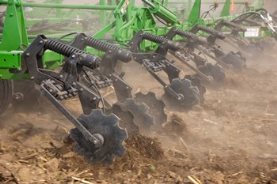 Adjustable closing disks operating in worked ground
Adjustable closing disks operating in worked ground

The closing disk system is standard equipment on the conventional models and is not available on the chisel models. As the nutrient knife places anhydrous, closing disks reduce soil disturbance while bringing the soil back for proper sealing. Soil types, moisture, and residue levels can greatly affect the amount and consistency of the soil that is brought back in. The closing disks on the 2430C can be adjusted from a narrow setting of 220 mm (8.8 in.) apart to the widest setting of 430 mm (17 in.) apart for industry leading adjustability.
The closing disk system on the 2430C requires no tools for adjustability. Fore-aft and lateral settings are pin adjustable and have variable down force. This makes for quick, easy adjustments that allow for customizable settings to meet field finish preferences. For increased productivity and ease of serviceability, there are no grease zerks on the closing disks assembly.
The 460-mm (18-in.) concave notched blades close the slot and seal the anhydrous in the soil. The closing disks are designed with down-pressure springs built in, which limits bounce in rough field conditions. The closing arms have been engineered to flex as large obstructions (clods/rocks/etc.) flow between the knife and the blade. Independent up and down travel arms are key to the nearly plug-free closing disk. This allows one machine to operate in any soil type and eliminates the need to have multiple disk sealer attachments along with labor required to change them out.
 Pin-adjust closing disk
Pin-adjust closing disk

Proven frame design
 3.4-m (134-in.) four-rank frame
3.4-m (134-in.) four-rank frame

The four-rank frame design of the 2430C has provided unmatched reliability to John Deere operators for over 10 years and a countless amount of acres. With operators requiring faster working speeds out of larger implements, machines require thicker frame tubes, additional diagonal bracing, and frame gussets to endure 600 engine horsepower tractors.
The frame stretches 3.40 m (134 in.) front-to-back, which allows for high levels of residue to easily flow through the staggered row units ensuring higher productivity and consistent nutrient placement. The large frame member sizes, tube-through-tube construction, and wheel module placement adds to the structural integrity, providing a stable front-to-rear and side-to-side operation.
The open frame design of the 2430C offers the ability to mount anhydrous distribution and nitrogen stabilizer systems in different locations throughout the bar based on user preference and convenience.
The ease of accessibility to the maintenance points of the machine is achieved through 1.1 m (44 in.) of underframe clearance. This enables the operator to save valuable time while experiencing less fatigue for routine maintenance and service.
Frame construction offers:
-
Consistent operating depth
-
Improved nutrient placement
-
Clear view of machine operation
-
Ease of serviceability
-
10 degrees up flex and 15 degrees down flex
Wheel configuration provides increased performance
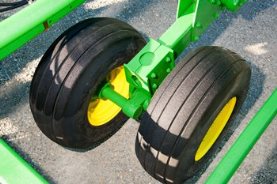 Walk-Over tandem wheels
Walk-Over tandem wheels
The wheel configuration of the 2430C provides increased performance with a total of 18 front castering and Walk-Over tandem wheels. This allows for excellent depth accuracy for following the contour of the terrain and provides greater flotation and maneuverability.
The staggered wheel design provides additional room for residue flow, obstacles, and transport stability. Ultimately, this setup leads to precise nutrient placement, eliminating gas-out while achieving increased application speeds in varying field conditions.
The front castering wheels provide good stability at the front of the machine and facilitate excellent turning, reducing tire scuffing. The rear-mounted walking tandem wheels maintain a level frame for increased operating speeds over rough fields.
Precise and accurate depth control
The 2430C Nutrient Applicator is designed for precise and accurate depth control. TruSet™ and single-point depth control come as standard equipment, and side-to-side depth control is available as an option. Both provide accurate depth control to ensure exact nutrient placement and best utilize tractor horsepower.
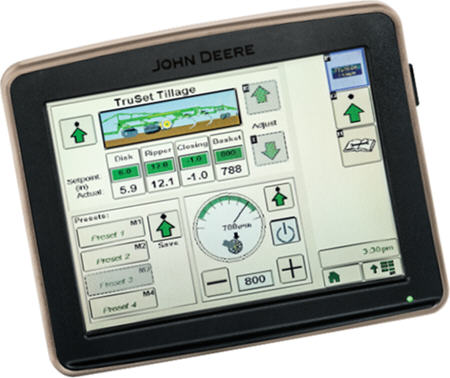 TruSet on a GreenStar™ 3 2630 display
TruSet on a GreenStar™ 3 2630 display
With TruSet, depth adjustments can be done on-the-go, increasing productivity and making the day easier for operators. TruSet provides accurate and precise depth control by the use of individual wheel sensors and electronic circuitry to perform tasks of leveling and depth measurements. TruSet depth is displayed to the nearest 2.5 mm (1/10 in.).
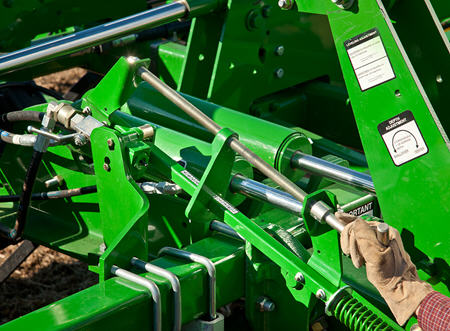 Single-point depth control
Single-point depth control
The field-proven single-point depth control offers the producer one easy, front-mounted crank to dial in their depth control for the entire implement. From one location, this adjustment is easily and quickly completed.
Conventional or chisel standards available
The Tru-Depth™ heavy-duty cast standards on the 2430C Nutrient Applicators are designed for precise and accurate nutrient placement and offer 567 kg (1250 lb) of trip force to allow for faster operating speeds. The conventional standard comes as base equipment and the parabolic chisel standard is available as an option. This option includes standards, closing disks, and coulters.
 Conventional heavy-duty Tru-Depth standard
Conventional heavy-duty Tru-Depth standard
The Tru-Depth conventional heavy-duty cast standard allows for application from 100-mm (4-in.) to 250-mm (10-in.) deep. With a trip height of 279 mm (11 in.), the standard is able to handle field obstacles and reset back to the operating depth with no shear bolt replacement. This reduces downtime spent replacing shear bolts, which leads to increased productivity. This option does not include closing disks or coulters.
 Heavy-duty cast Tru-Depth standard
Heavy-duty cast Tru-Depth standard
The Tru-Depth heavy-duty cast chisel standard allows operators to perform tillage up to 305-mm (12-in.) deep and gives them the ability to perform nutrient application and tillage in one pass. The standard is designed to mix and bury residue to promote decomposition and encourage faster soil warming.
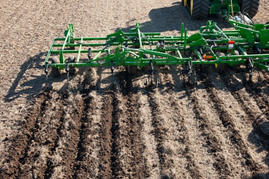 Chisel on left, conventional on right
Chisel on left, conventional on right
Single-point depth control
 Single-point depth control
Single-point depth control

Single-point depth control has always been a popular choice with producers.
The easy crank-adjustment handle in one convenient location controls the depth of the entire machine. The depth stop and valve are mounted directly to the frame and cylinder pins for precise, repeatable depth settings.
Five-section implements utilize four cylinders on the mainframe, two on each side in a combination parallel-series hydraulic path. The mainframe cylinders work together, acting as a hydraulic rockshaft maintaining side-to-side depth integrity.
Single point:
- Provides 3-mm (1/8-in.) operating depth change per turn
- Simple up-front location depth adjustment for entire machine
- Cylinder eyebolts adjust for frame leveling
- Valve assembly attached to frame and cylinder pins promotes consistent and repeatable valve activation
Features
4600 CommandCenter™ display with SpreadStar™ system
 Run screen
Run screen
The F4365 is utilizing the 4600 CommandCenter display that is also found in large tractors today. The CommandARM™ controls, Generator 4 CommandCenter display and SpreadStar have been updated and tailored to the needs of operators allowing them to see all key functions on one run screen including AutoTrac™ assisted steering system, variable rate documentation, field totals, and dry spinner spreader settings. Click anywhere on the display to expand and easily adjust information.
 Work setup
Work setup
To prepare for field application, simply press the Setup button in the bottom left corner of the display run page, and it will direct the user to the Work Setup window.
- Select the Location box to setup user information including farm, field, and client. User information is not required to load and execute a variable-rate prescription.
- Select the Equipment box to do the initial setup of the machine including the number of bins in the dry spinner spreader.
- The Work Summary box shows a link for each bin in the dry spinner spreader. The screenshot above is for a two-bin dry box. Select each one to input or change the name of the product that will be applied. Twenty-four unique names can be entered into the display for various product types such as single product, blended product, or multi-product variable rate. The user can also choose the target rate for spreading or load a variable-rate prescription.
 SpreadStar
SpreadStar
Once the Work Setup Window is complete, the updated SpreadStar application can then be used to input and setup the following:
 Target spread rate
Target spread rate
 Bin details
Bin details
Target spread rate – selecting the target rate box allows the operator to quickly adjust three different target rates or load a prescription if needed. The target rates can be adjusted when spreading by using the corresponding buttons on the CommandARM.
Product density/product applied – selecting either of these areas will take the user to a bin details page where more frequent dry spinner spreader inputs and adjustments are made. For dry spinner spreaders with multiple bins, individual tabs at the top of the screen make it easy to quickly toggle between them.
Features on the bin details page include:
- Bin on/off
- Bin chaining (not shown)
- Product density
- CFR value
- Feed gate opening
- Bin alarms
- Resetting bin counter
- Belt prime
- Tarp control
- Chain oiler
Spinner Settings
 Spinner settings
Spinner settings
The last step is to setup the spinner settings by clicking on the spinner settings box in the SpreadStar application. The Add Spinner preset window will come up allowing the operator to create a new preset if they choose.
Preset functions include:
- Spinner target speed
- Spinner target speed alarms
- Spread width
- Fan frame setting
The bin details and spinner settings are saved with the Work Summary details. For example, an operator with a two-bin dry spreader may need to change between a two product variable-rate to a single blend application using bin chaining. When the operator switches back to two product variable rate, SpreadStar will automatically remember the bin details and spinner settings that were last used with that configuration.
Even with this feature, it is still important to calibrate the dry spinner spreader when changing products to ensure an accurate and consistent spread pattern.
Superior ride quality with dual c-channel chassis design
 Dual c-channel chassis
Dual c-channel chassis
The F4365 uses a dual c-channel frame design with leaf spring suspension to maximize ride quality and durability. The dual c-channel frame design is very strong, but it still allows the frame to flex. This is especially important when operating in rough field conditions at higher speeds because the frame will flex and absorb some of the impact loads instead of transferring it to the rest of the machine including the operator.
 Rear axle
Rear axle
Industry-proven AxleTech™ axles are used on the front and rear and are designed to haul full loads of heavier-density products such as lime.
 Front axle leaf spring
Front axle leaf spring
 Rear axle leaf spring
Rear axle leaf spring
Parabolic leaf springs are used on the front axle in conjunction with dampers and offer an industry-best 102 mm (4 in.) of travel. Parabolic leaf springs have fewer leaves, which reduce internal friction allowing for easier compression and articulation.
Dual-rate leaf springs are used on the rear axle to ensure consistent ride quality regardless of how much product is in the box. The first smaller set of leaf springs is used when the box is empty. When the box is loaded, the first set of leaf springs fully engages and combines with the second larger set of leaf springs. This design helps the F4365 drive and ride more consistently when applying in the field or in transport on the road.
The dual c-channel design, coupled with best-in-class suspension, helps absorb the impact loads and protects the operator and machine from harmful vibration. Reducing vibration improves productivity by reducing operator fatigue and decreasing the potential for failures caused by them.
Storage compartment
 External storage compartment
External storage compartment
An external storage compartment is located on the left-hand side of the machine and can be used to store important items nearby, but outside the cab:
- Personal protective equipment (PPE), such as gloves, goggles, face shield, apron, and emergency clothing
- Grease gun
- Density check tool
- Tools
Hydraulic folding ladder
 Hydraulic folding ladder
Hydraulic folding ladder
Operators will climb into the F4365 via a hydraulically controlled front ladder similar to 4 Series Sprayers. When the machine starts to move, the ladder will automatically fold up. When the machine stops, the operator simply hits the ladder button on the CommandARM™ control center to unfold it.
Cab and dry spinner spreader platforms
 Cab platform
Cab platform
 Spreader platform
Spreader platform
This industry-exclusive feature allows the operator to safely exit the cab and walk back to the dry spinner spreader to help with tendering or do a product density check.
Front retrieval points
 Front retrieval points
Front retrieval points
If the machine does get stuck while operating in wet conditions, retrieval points are located on the front of the frame to assist in pulling the machine out.
Fenders and mud flaps
 Front fender
Front fender
 Rear mud flaps
Rear mud flaps
Front and rear fenders protect the F4365 from mud and debris when operating in the field. Large front fenders similar to what are used on large row-crop tractors protect the front of the machine, even when turning. Rear mud flaps attached to the dry spinner spreader platforms on the right and left side provide excellent protection from debris thrown by the rear tires.
Optimal weight distribution
F4365 High-Capacity Nutrient Applicator and bin configuration |
Machine weight |
Front weight |
Rear weight |
Weight distribution (percent) |
|
Front |
Rear |
||||
Base machine with Single-Bin DN495 (empty) |
13,764 kg |
6,597 kg |
7,167 kg |
48 percent |
52 percent |
Base machine empty with Dual- Bin DN495 (MultApplier) |
14,444 kg |
6,623 kg |
7,821 kg |
46 percent |
54 percent |
Base machine empty with Four- Bin DN495 (MultiBin) |
14,556 kg |
6,407 kg |
8,149 kg |
44 percent |
56 percent |
Operator-friendly cab, controls, and display
CommandView™ III cab features and enhancements
 CommandView III cab panoramic view
CommandView III cab panoramic view
The F4365 High-Capacity Nutrient Applicator offers the same spacious CommandView III cab found in larger John Deere tractors and the 4 Series Self-Propelled Sprayers. This cab will keep operators comfortable all day long while providing great visibility and increasing productivity.
CommandARM™ controls
 CommandARM close up
CommandARM close up
The CommandARM has been updated and tailored for the specific needs of an operator. The AutoTrac™ assisted steering system resume and Master on/off buttons, along with the boom raise/lower switches are located conveniently on the multifunction handle, so the operator does not have to move their hand during application and headland turns. Additional controls for lighting, heating ventilation air conditioning (HVAC), radio, dry spinner spreader, and more are located conveniently close by.
CommandARM storage
 USB charging ports
USB charging ports
There are USB charging ports inside the storage compartment on the CommandARM armrest. These USB outlets are for charging only and do not connect to the radio or 4600 CommandCenter™ Display.
Generation 4 CommandCenter display
 4600 CommandCenter Display
4600 CommandCenter Display
The F4365 uses the Generation 4 CommandCenter display, similar to what is being used in larger tractors and sprayers today. SpreadStar™ system has also been updated to allow operators to see all key functions on one run screen including AutoTrac, John Deere Section Control, mapping, and application system settings. Importing and exporting user information and application data has been simplified and improved with Wireless Data Transfer, John Deere Operations Center, and AgLogic™ system.
Multifunction handle
 Multifunction handle
Multifunction handle
The multifunction handle gives operators convenient access to important nutrient applicator controls.
Operations that are controlled from the handle include:
- Raise/lower (fold/unfold) boom
- Center boom raise/lower
- Index boom section (IBS) control system
- Speed range
- Master system on/off
- AutoTrac resume
- Headland Management System (HMS)
- Emergency off
- Six reconfigurable buttons
Reconfigurable buttons
 Reconfigurable buttons on multifunction handle
Reconfigurable buttons on multifunction handle
 Speed range selector scroll wheel on multifunction handle
Speed range selector scroll wheel on multifunction handle
There are a total of nine reconfigurable buttons, six located on the multifunction handle and three on the CommandARM. Each button can be configured to one of the functions listed below:
- Master on
- Bin chaining
- Left tilt up/down
- Right tilt up/down
- Run page cycle forward
- Run page cycle back
- Swap track
- AutoTrac shift track center
- AutoTrac shift track left
- AutoTrac shift track right
- Close overlay
ComfortCommand™ seat
 Cab interior looking in from the door
Cab interior looking in from the door
The same great ComfortCommand seat in the 4 Series Sprayer is installed in the F4365 Nutrient Applicator. The seat provides superior ride quality with the ability to swivel 15 degrees to the right, improving operator comfort during application.
Additional cab features and options include a leather seat, Bluetooth® wireless system capability, a premium sound system, power mirrors, rear window tint, right-hand window wiper with fluid, and many more.
By keeping operators more comfortable during the day, the CommandView III cab will improve productivity while reducing the fatigue they experience throughout the day.
Bluetooth is a trademark of Bluetooth SIG Incorporated.
Improved machine performance equals more productivity
Engine and transmission
 9-L PowerTech™ engine
9-L PowerTech™ engine
 Infinitely Variable Transmission (IVT™)
Infinitely Variable Transmission (IVT™)
The F4365 uses an industry-proven 9-L PowerTech engine combined with an IVT to provide maximum power and efficiency.
The 9-L (549 cu in.) engine provides 272 kW (365 hp) rated horsepower and up to 298 kW (400 hp) peak horsepower when needed.
The IVT is common to the 8R Tractor Family, but has been modified for higher field and transport speeds.
Applicator field and transport speeds
 F4365 spreading in the field
F4365 spreading in the field
 F4365 in transport
F4365 in transport
The F4365 can apply product up to 48 km/h (30 mph) in field and travel on the highway empty at speeds up to 74 km/h (46 mph). The engine and transmission are common to other product lines in John Deere which means service locations, service intervals, and parts are all common.
 Fuel filling
Fuel filling
To ensure the F4365 can run all day long, it comes equipped with a 567-L (150 gal.) fuel tank and 29.5-L (7.8 gal.) diesel exhaust fluid (DEF) tank located on the right side of the machine. The slender tank designs are attached to the dual c-channel frame, reducing the torque load the tanks can have on the frame when full. Both tanks can be easily filled from ground level.
More versatility with the DN495 Dry Spinner Spreader
New Leader® Dry Spinner Spreader
The F4365 uses an industry-proven New Leader Dry Spinner Spreader. This 4.27-m (14-ft) long dry box is capable of holding 9.34 m3 (330 ft³) of product and is available in multiple configurations to meet a variety of application needs. Depending on the product, spread widths can range from 18.29 to 27.43 m (60 to 90 ft).
Single bin option
 Single bin option
Single bin option
The single bin option can be ordered in a 304 Stainless Steel or a 409 Painted Stainless Steel. A removable end gate, inverted V, and electric oiler come in base. At 24 km/h (15 mph), the single bin can spread fertilizer at rates as high as 499 kg (1100 lb) per acre or spread lime at rates as high as 2994 kg (6600 lb) per acre.
MultApplier insert
 Two-bin MultApplier insert
Two-bin MultApplier insert
A 2.1-m (7.0-ft) 304 Stainless-Steel MultApplier insert can be added to the single bin to spread two products at once. The MultApplier uses a belt over stainless-steel conveyor chain so no oil is necessary. Simply remove the end gate of the single bin to install the MultApplier insert.
MultiBin insert
 Four-bin MultiBin insert
Four-bin MultiBin insert
A 304 Stainless-Steel MultiBin insert can be added to the single bin to spread up to four products at once. In addition to the second large bin, two micronutrient bins are on the back of the MultiBin. Similar to the MultApplier insert, the MultiBin conveyor chain is belt over stainless-steel conveyor chain and does not require oil.
The divider separating the two micronutrient bins on the rear can also be removed to make one large micronutrient bin. Standard rate metering rollers come in base with the MultiBin insert. A pneumatically controlled lid covers the micronutrient bin(s) opening and is operated in the Generation 4 CommandCenter™ display.
New Leader is a trademark of Highway Equipment Company.
Improve application accuracy with the AB485 Air Boom


For ag service providers and large-scale producers, the AB485 Air Boom is available as an option for the F4365 High-Capacity Nutrient Applicator. The AB485 Air Boom builds on the advantages of the F4365 chassis with the addition of an 8.5-m3 (300-cu ft) dry box with dual-product capability and a 21.3-m (70-ft) wide boom.
Durability and uptime are extremely important to an ag retailer’s business. With the number of acres these machines need to cover each year and the varying weather conditions that can impact the schedule, increasing uptime is crucial to the profitability and success of the ag retailer. The AB485 Air Boom has been designed to maximize uptime through improved performance, reliability, and operator comfort.
Performance
 AB485 Air Boom
AB485 Air Boom
The air boom option allows operators to accurately apply dry fertilizer across a wide 21.3-m (70-ft) swath at speeds up to 48.3 km/h (30 mph), and at maximum rates up to 544.3 kg (1,200 lb) per acre at 16.1 km/h (10 mph). With its 8.5-m3 (300-cu ft) capacity dry box and dual-bin configuration, operators can simultaneously apply up to two products at variable rates to better meet crop nutrient needs with fewer passes over the field. Application accuracy is further improved with half-width section control.
 Air distribution system
Air distribution system
The air distribution system is an efficient design that consistently delivers even air flow from the fan to the booms. The closed-loop speed control allows the fan to run independent of the motor speed, making it more efficient as well. This design requires less power for the air system and puts more engine power to the ground during acceleration and operation.
Reliability
The electrical and hydraulic systems have been designed from the ground up with full integration into the 4600 CommandCenter™ Display for easier control and maintenance. The boom structure and supports have also been strengthened to extend the life of the booms regardless of the terrain.
 Fan oil cooler
Fan oil cooler
 Fan air intake with screen
Fan air intake with screen
To improve the reliability of the air distribution system, the fan oil cooler is mounted on the right side of the machine, exposing it to less dust and vibration while making it easier to maintain. A large screen was also added over the fan air intake to block residue and debris from entering the air system.
Operator comfort
 Hand rails on both sides of the dry box
Hand rails on both sides of the dry box
The front ladder provides easy access to the machine even when the booms are folded. During tendering, operators can quickly access the top of the dry box from the cab platform. Hand rails can then be folded up on both sides of the dry box, allowing the operator to work more efficiently.
The F4365 with the AB485 Air Boom improves the revenue potential for ag service providers by increasing machine productivity through greater durability and superior field performance.
Maximize seasonal capabilities with the LS475 Liquid System
 F4365 applying with the LS475 Liquid System
F4365 applying with the LS475 Liquid System
Seasonal flexibility is crucial for maximum machine utilization, and the seasonal capabilities of the F4365 are maximized with the LS475 Liquid System option. Together with Hagie™ Manufacturing, this liquid system is designed as a complete package with industry-leading advantages. Learn more on the LS475 product page.
Accurately apply low-rate herbicide and high-rate fertilizer with a single machine
 LS475 applying in the field
LS475 applying in the field
During the busy spring season, you need to complete jobs as crops are planted, from applying high-rate fertilizer on unplanted corn fields to low-rate pre-emergent herbicide on soybeans. Dual centrifugal solution pumps with dedicated magnetic flow meters work together to achieve pin-point rate accuracy through the entire flow range between 18.9 and 1589.9 L/min (5 and 420 gpm).
Fast, clean, automated tank filling enabled by PowrSpray™ technology
 LS475 load system keypad
LS475 load system keypad
When the tank is empty, every second counts trying to get back into the field. PowrSpray features independent fill and spray circuits with dedicated pumps to maximize flow. The dedicated self-priming transfer pump can fill the solution tank at over 1135.6 L/min (300 gpm). This PowrSpray system can:
- Automatically fill to a predefined tank level while automatically adjusting engine speed
- Pull fresh water from the rinse tank to clean the fill system
- Be manually reduced if a slower fill rate is desired
- Pause filling, giving you sufficient time to add ingredients and rinse containers
- Allow for quick and easy operation at the load station for all skill levels
Cover more acres per pass using the widest factory-installed boom
 LS745 boom
LS745 boom
The time-proven 27.4-m (90-ft) 4 Series Sprayer steel boom unlocks reliable productivity for ag service providers. This durable boom features:
- Full-boom breakaway
- Tri-direction boom-tip breakaway
- Auto-fold
The standard dual plumbing system features 76.2-cm (30-in.) off-center high-flow nozzle bodies (turrets) and a 152.4-icm (60-in.) on-center cam-lock. When configured for 152.4-cm (60-in.) cam-lock spacing, the effective spray pattern is 29 m (95 ft). The 76.2-cm (30-in.) nozzle body configuration achieves a 27.4-m (90-ft) spray pattern.
Cover more acres between refills with the large solution and rinse tanks
 LS475 solution and rinse tanks
LS475 solution and rinse tanks
With higher-speed planting, the season is becoming more condensed every year. When you need to get acres covered, getting tender trucks back to the plant increases productivity. To hold more product onboard, the LS475 solution system features a stainless steel 7570.8-L (2000-gal.) solution tank and black poly 757.1-L (200-gal.) rinse tank.
The large solution tank allows operators to cover more acres between refills. This tank gets tender trucks empty faster and back on the road, translating into less idle time for the tender truck and you and quicker load turn-arounds.
Hagie is a trademark of Hagie Manufacturing Company, LLC and similar to John Deere branded equipment, Deere will also support Hagie equipment.
Features
CommandDrive™ powertrain delivers improved efficiency with Auto Mode
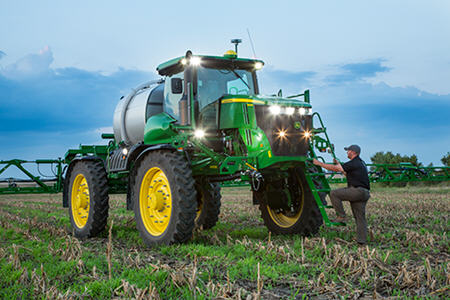 Experience fuel saving and noise reduction with CommandDrive
Experience fuel saving and noise reduction with CommandDrive
Spray more acres per day at a lower cost of operation with the CommandDrive powertrain. You will see an improved system response to maintain consistent application and transport speeds in challenging conditions, while reducing overall fuel consumption and cab noise.
The CommandDrive powertrain comes in base on all R4060 and R4045 Sprayers. This powertrain has the following features:
- Auto Mode dynamically commands engine speed depending on load requirements
- Reduce engine speed and save up to 20 percent on fuel consumption
- 3- to 5-decibel reduction in noise for long hours in the cab
- Single pump flow instead of two
- Improved traction control
Operator controls within easy reach in CommandView™ III cab with integrated GreenStar™ 4600 CommandCenter™ display
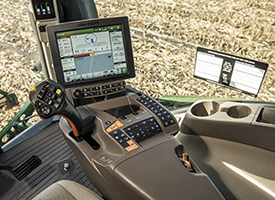 4 Series Sprayer operator station
4 Series Sprayer operator station
When operators first enter the Command View III cab, they will notice that significant changes have been made. Key sprayer controls are more easily accessible to the operator on the redesigned CommandARM™ control panel and the multifunction handle has a more ergonomic fit and feel.
The multifunction handle has six reconfigurable buttons, a scroll to select speed range, and allows operators to better manage their headlands with the Headland Management System (HMS™) button. To finish out the upgrades, the GreenStar™ display has been upgraded to a faster, more user-friendly 4600 CommandCenter™ display, which allows operators to efficiently capture, manage, and transfer data.
Comfort continues to be enhanced by the ComfortCommand™ seat, which offers both fore-aft and lateral attenuation along with 15 degrees of right-hand seat swivel on all cab options. For first-class comfort, the premium cab offers a heated/ventilated leather seat and light-emitting diode (LED) cab lights.
The 4 Series Sprayers are JDLink™ telematics system capable, which enable features such as John Deere Wireless Data Transfer (WDT), Service ADVISOR™ Remote diagnostics, and Remote Display Access (RDA). These integrated solutions enable additional uptime and reduce cost of operation. All of the CommandView III cab features allow operators to run longer hours, increasing the ability to get more acres sprayed in a day.
Steel and carbon-fiber booms feature swing-link suspension for optimum stability
Make fewer passes through the field and reduce compaction, as well as time spent spraying, with John Deere booms.
All John Deere booms are more stable due to the swing link suspension, which helps translate rough areas in the field into horizontal (side-to-side) movement of the boom rather than lateral (up and down) movement. This additional stability means increased productivity as the boom now has the ability to more accurately maintain spray height above the crop, delivering a precise spray pattern. The swing link suspension also translates into uptime as the additional stability means less crop damage, resulting in less mechanical boom damage.
The enhanced design allows the boom to unfold and fold faster, getting the operators into the field quicker, and the flat fold design delivers superior transport visibility.
Automate tasks from filling station with Solution Command System
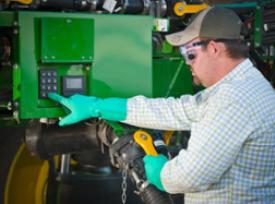 Solution Command offer push button loading
Solution Command offer push button loading
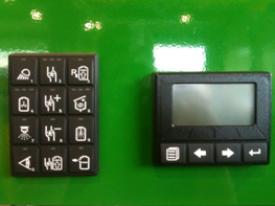 12-button keypad and micro-display
12-button keypad and micro-display
4 Series Sprayers are available with the SCS and have been completely redesigned to allow quick and easy operation at the load station for all operator skill levels. The optional system allows complete automation at the load station with a 12-button keypad. The features include the following:
- Fill station light on/off
- Pump on/off
- Agitation
- Pump speed increase
- Pump speed decrease
- Eductor on/off
- Master on/off
- Automated rinse cycle
- Visual nozzle check
- Pull-on fill
- Push-on fill
- Target fill
The system also features a micro-display, providing real-time feedback on the system operations, as well as ability to select a rinse method and the ability to monitor progress during the automated rinse function. Overall, the enhanced Solution Command System increases operational performance by increasing ease of use through automation at the load station.
Load Command™ enables fastest loading speeds for maximum efficiency
 Quick loading with the Load Command system
Quick loading with the Load Command system
Load at speeds as fast as 1500 L/min (400 gpm) with the fully integrated Load Command system available for John Deere’s largest sprayer models. This highly efficient loading time allows for more spraying time or more acres per day while complementing the machine’s three-season asset-utilization value.
How it works
Load Command allows the operator to pull the sprayer up to the tender unit, couple the Load Command tender arm to the Load Command coupler on the sprayer, and receive a full 4542-L (1200-gal.) load in as fast as 3 minutes and a full 6057-L (1600-gal.) load in 4 minutes.
| Model | Tank size | Load time |
| R4045 | 4542 L (1200 gal.) | 3 minutes |
| R4060 | 6057 L (1600 gal.) | 4 minutes |
Load Command dramatically reduces the fill time and the amount of operator interface time. When the system completes loading, the couplers automatically disengage from each other. This allows the operator to remain in the cab with the ability to quickly return to spraying.
By providing improved loading times, the John Deere R4045 and R4060 Sprayers with Load Command are more versatile, more productive, and will provide a better overall return on investment.
With the ability to create more spraying time, the Load Command system enables a custom applicator to achieve more value by applying products more efficiently and, in turn, generating more revenue per season.
Compatibility
Load Command can be ordered from the factory for R4045 and R4060 Sprayer models equipped with Auto Fill. Load Command is also available as a performance upgrade kit for existing 4930, 4940, R4045, and R4060 Sprayers.
NOTE: Load Command and Front Fill are not compatible to be installed on the machine at the same time.
ExactApply™ nozzle control delivers precise application with up to 20 acres per hour of added productivity
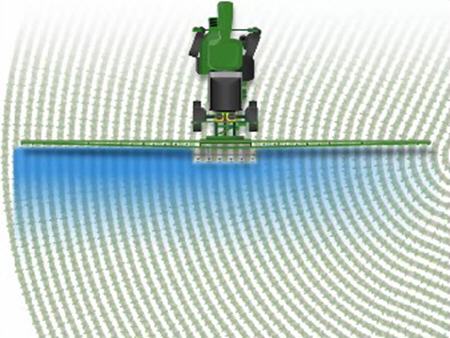 Turn compensation mode
Turn compensation mode
 Individual nozzle control mode
Individual nozzle control mode
John Deere’s intelligent nozzle control system ExactApply helps producers better manage drift and deliver a precise application. By maintaining target rate and pressure over a wider speed range, ExactApply can improve productivity up to 20 acres per hour*.
*NOTE: Assumes a 3.2-km/h (2-mph) average operating speed increase.
ExactApply is offered as a factory-installed option as well as a performance upgrade kit that can be added to existing 4 Series Sprayer models.
How it works
The ExactApply system features multiple modes of operation including pulse-width modulation (PWM) and individual nozzle control:
- 15-Hz PWM pulses one solenoid to achieve a consistent droplet size and maintain spray pressure throughout a wider range of speeds and application rates.
- 30-Hz PWM (combined mode) pulses both solenoids in the ExactApply nozzle body at 15 Hz, providing superior coverage. Combined mode allows ExactApply to have a 25 percent increased flow over current competitive systems in the market.
- AutoSelect A/B automatically switches between two nozzles to maintain the desired spray pressure range while spraying conventionally.
- Turn compensation varies the rate across the boom, ensuring the desired application rate. The rate decreases on the inside of the turn to not subject crop to chemical burn, while the rate on the outside of boom increases, ensuring the crop receives the desired application rate.
- Individual nozzle control minimizes overlap by controlling product application through individual nozzles. This reduces chemical cost and ensures the product is placed where it is needed most. In comparison, traditional nozzle control functions in 11 sections, meaning section widths vary from 2.4 to 3.35 m (8 to 11 ft), depending upon boom width.
Precision Ag Technology enables you to monitor performance and maximize productivity
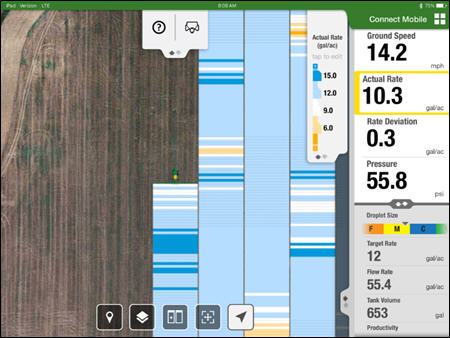 Connect Mobile actual rate map and pressure map in split screen gives the operator deeper understanding of machine performance
Connect Mobile actual rate map and pressure map in split screen gives the operator deeper understanding of machine performance
Connect Mobile overview
John Deere Connect Mobile is a solution that utilizes an Apple® iPad® tablet in the cab that provides the operator a better understanding of the sprayer’s performance. Connect Mobile documents and displays several sprayer performance attributes, helping the operator monitor and more easily detect problems that can occur while spraying. Connect Mobile also has a common user interface that makes it easy to use between different pieces of John Deere equipment. Once the job is done, the iPad with the spraying data can be utilized to perform basic crop scouting activities in the field.
Spraying attributes
Monitor key performance indicators in map layers and dashboard tiles such as:
- Actual rate
- Rate deviation
- Pressure
- Ground speed
- Droplet size
- Target rate
- Flow rate
- Tank volume
- Productivity
- Fuel rate
In base equipment
Connect Mobile hardware is factory installed on all model year 2017 and newer R4030, R4038, R4044, R4045, and R4060 Sprayers, making it easy to get started with Connect Mobile.
Learn more about Connect Mobile in the Field and Crop Solutions section within the Precision Ag Technology product line and how it can improve the quality of a spraying job.
iPad and Apple are trademarks of Apple Inc.
Increase versatility with a DN456 Dry Spinner Spreader
Keep your machines working for you by converting them to dry nutrient applicators with the addition of a New Leader® DN456 Dry Spinner Spreader. This conversion can be completed in as little as 4 hours and involves the removal of the wet solution skid and the installation of the dry spinner spreader.
The DN456 features a carrying capacity of up 5.6 m3 (200 cu ft) or 6.6 tons of dry fertilizer (not approved for ag lime) and is capable of variable rate applications from 34 kg/ha (75 lb/acre) up to 3 ton/acre. The 1.83-m (72-in.) spinner heights allow spread width up to 32 m (105 ft) as it propels material across the pass. The New Leader G4 spinner technology provides a consistent spread pattern across the field for uniform pass to pass application.
The DN456 can be ordered with either 304 stainless-steel or 409 painted spreader material in single or dual product bin configurations with a #4 belt over chain conveyor.
New Leader is a registered trademark of Highway Equipment Company.
Features
Operator controls within easy reach in CommandView™ III cab with integrated GreenStar™ 4600 CommandCenter™ display
 4 Series Sprayer operator station
4 Series Sprayer operator station
When operators first enter the Command View III cab, they will notice that significant changes have been made. Key sprayer controls are more easily accessible to the operator on the redesigned CommandARM™ control panel and the multifunction handle has a more ergonomic fit and feel.
The multifunction handle has six reconfigurable buttons, a scroll to select speed range, and allows operators to better manage their headlands with the Headland Management System (HMS™) button. To finish out the upgrades, the GreenStar™ display has been upgraded to a faster, more user-friendly 4600 CommandCenter™ display, which allows operators to efficiently capture, manage, and transfer data.
Comfort continues to be enhanced by the ComfortCommand™ seat, which offers both fore-aft and lateral attenuation along with 15 degrees of right-hand seat swivel on all cab options. For first-class comfort, the premium cab offers a heated/ventilated leather seat and light-emitting diode (LED) cab lights.
The 4 Series Sprayers are JDLink™ telematics system capable, which enable features such as John Deere Wireless Data Transfer (WDT), Service ADVISOR™ Remote diagnostics, and Remote Display Access (RDA). These integrated solutions enable additional uptime and reduce cost of operation. All of the CommandView III cab features allow operators to run longer hours, increasing the ability to get more acres sprayed in a day.
Steel and carbon-fiber booms feature swing-link suspension for optimum stability
Make fewer passes through the field and reduce compaction, as well as time spent spraying, with John Deere booms.
All John Deere booms are more stable due to the swing link suspension, which helps translate rough areas in the field into horizontal (side-to-side) movement of the boom rather than lateral (up and down) movement. This additional stability means increased productivity as the boom now has the ability to more accurately maintain spray height above the crop, delivering a precise spray pattern. The swing link suspension also translates into uptime as the additional stability means less crop damage, resulting in less mechanical boom damage.
The enhanced design allows the boom to unfold and fold faster, getting the operators into the field quicker, and the flat fold design delivers superior transport visibility.
Automate tasks from filling station with Solution Command System
 Solution Command offer push button loading
Solution Command offer push button loading
 12-button keypad and micro-display
12-button keypad and micro-display
4 Series Sprayers are available with the SCS and have been completely redesigned to allow quick and easy operation at the load station for all operator skill levels. The optional system allows complete automation at the load station with a 12-button keypad. The features include the following:
- Fill station light on/off
- Pump on/off
- Agitation
- Pump speed increase
- Pump speed decrease
- Eductor on/off
- Master on/off
- Automated rinse cycle
- Visual nozzle check
- Pull-on fill
- Push-on fill
- Target fill
The system also features a micro-display, providing real-time feedback on the system operations, as well as ability to select a rinse method and the ability to monitor progress during the automated rinse function. Overall, the enhanced Solution Command System increases operational performance by increasing ease of use through automation at the load station.
ExactApply™ nozzle control delivers precise application with up to 20 acres per hour of added productivity
 Turn compensation mode
Turn compensation mode
 Individual nozzle control mode
Individual nozzle control mode
John Deere’s intelligent nozzle control system ExactApply helps producers better manage drift and deliver a precise application. By maintaining target rate and pressure over a wider speed range, ExactApply can improve productivity up to 20 acres per hour*.
*NOTE: Assumes a 3.2-km/h (2-mph) average operating speed increase.
ExactApply is offered as a factory-installed option as well as a performance upgrade kit that can be added to existing 4 Series Sprayer models.
How it works
The ExactApply system features multiple modes of operation including pulse-width modulation (PWM) and individual nozzle control:
- 15-Hz PWM pulses one solenoid to achieve a consistent droplet size and maintain spray pressure throughout a wider range of speeds and application rates.
- 30-Hz PWM (combined mode) pulses both solenoids in the ExactApply nozzle body at 15 Hz, providing superior coverage. Combined mode allows ExactApply to have a 25 percent increased flow over current competitive systems in the market.
- AutoSelect A/B automatically switches between two nozzles to maintain the desired spray pressure range while spraying conventionally.
- Turn compensation varies the rate across the boom, ensuring the desired application rate. The rate decreases on the inside of the turn to not subject crop to chemical burn, while the rate on the outside of boom increases, ensuring the crop receives the desired application rate.
- Individual nozzle control minimizes overlap by controlling product application through individual nozzles. This reduces chemical cost and ensures the product is placed where it is needed most. In comparison, traditional nozzle control functions in 11 sections, meaning section widths vary from 2.4 to 3.35 m (8 to 11 ft), depending upon boom width.
Precision Ag Technology enables you to monitor performance and maximize productivity
 Connect Mobile actual rate map and pressure map in split screen gives the operator deeper understanding of machine performance
Connect Mobile actual rate map and pressure map in split screen gives the operator deeper understanding of machine performance
Connect Mobile overview
John Deere Connect Mobile is a solution that utilizes an Apple® iPad® tablet in the cab that provides the operator a better understanding of the sprayer’s performance. Connect Mobile documents and displays several sprayer performance attributes, helping the operator monitor and more easily detect problems that can occur while spraying. Connect Mobile also has a common user interface that makes it easy to use between different pieces of John Deere equipment. Once the job is done, the iPad with the spraying data can be utilized to perform basic crop scouting activities in the field.
Spraying attributes
Monitor key performance indicators in map layers and dashboard tiles such as:
- Actual rate
- Rate deviation
- Pressure
- Ground speed
- Droplet size
- Target rate
- Flow rate
- Tank volume
- Productivity
- Fuel rate
In base equipment
Connect Mobile hardware is factory installed on all model year 2017 and newer R4030, R4038, R4044, R4045, and R4060 Sprayers, making it easy to get started with Connect Mobile.
Learn more about Connect Mobile in the Field and Crop Solutions section within the Precision Ag Technology product line and how it can improve the quality of a spraying job.
iPad and Apple are trademarks of Apple Inc.
Increase versatility with a DN456 Dry Spinner Spreader
Keep your machines working for you by converting them to dry nutrient applicators with the addition of a New Leader® DN456 Dry Spinner Spreader. This conversion can be completed in as little as 4 hours and involves the removal of the wet solution skid and the installation of the dry spinner spreader.
The DN456 features a carrying capacity of up 5.6 m3 (200 cu ft) or 6.6 tons of dry fertilizer (not approved for ag lime) and is capable of variable rate applications from 34 kg/ha (75 lb/acre) up to 3 ton/acre. The 1.83-m (72-in.) spinner heights allow spread width up to 32 m (105 ft) as it propels material across the pass. The New Leader G4 spinner technology provides a consistent spread pattern across the field for uniform pass to pass application.
The DN456 can be ordered with either 304 stainless-steel or 409 painted spreader material in single or dual product bin configurations with a #4 belt over chain conveyor.
New Leader is a registered trademark of Highway Equipment Company.
Features
Hopper made of anti-shock, reinforced fiberglass
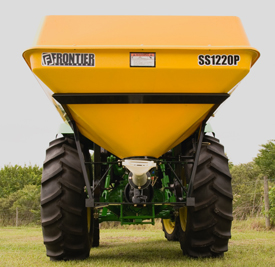 Superior corrosion resistance
Superior corrosion resistance
The reinforced fiberglass hopper on the 12 Series Pendular Spreader provides superior corrosion resistance, resulting in stronger durability and longer wear life.
It has a frame made of sturdy, tubular steel and is painted with polyester resin powder coat for added corrosion resistance.
Spreader spout provides precision spreading
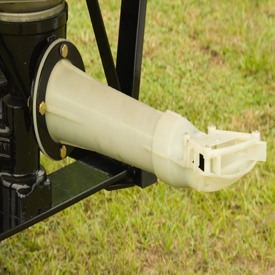 Standard spout
Standard spout
Frontier™ Pendular Spreaders are designed to provide a precise spread. To accommodate this, they can be outfitted with various spreader spouts.
The spreader spouts are made of nylon and reinforced fiberglass for corrosion resistance and increased durability.
By simply rotating the optional directional spout's tip, an easy spread adjustment can be made to the left only, to the right only, or to the middle.
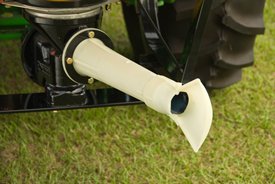 Optional left/right directional attachment
Optional left/right directional attachment
 Optional left/right directional attachment
Optional left/right directional attachment
Category 1 power take-off (PTO) driveline
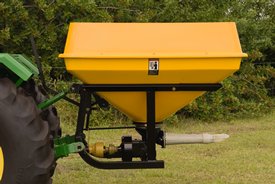 Cast-steel gearbox provides extended durability
Cast-steel gearbox provides extended durability
The 12 Series Pendular Spreader comes standard with a 540-rpm PTO, Category 1 driveline. Its heavy-duty shielded shaft, made in compliance with American Society of Agricultural and Biological Engineers (ASABE) requirements, is built to last and ensures operator safety.
The anti-wear, cast-steel gearbox operates in oil bath, providing a longer life and durability for the drive system.
Field-installed agitator kits for broadcast and pendular spreaders
All the field conversion agitator kits listed below allow operators to use multiple types of seed or fertilizer without clumping up.
Spout, deflector shields, and discharge kits for broadcast and pendular spreaders
Deflector shield conversion kits for broadcast spreaders ensure that material is thrown where the operator chooses.
Side-row discharge conversion kits for broadcast spreaders focus the spread to the side of the tractor.
The left-right direction attachment concentrates material to specific areas when using pendular spreaders.
A salt and sand spout kit and an optional locking nut are also available.
Filter grate prevents damage to pendular spreaders
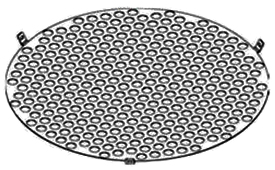 Filter grate drawing from operator's manual
Filter grate drawing from operator's manual

The filter grate kit is used when loading SS1079P, SS1116P, SS1180P, and SS1220P Pendular Spreaders. It keeps hard and clumpy material from damaging parts or clogging the spreader.
Hydraulic gate control kit for SS10P, SS11P, and SS12P Series Pendular Spreaders
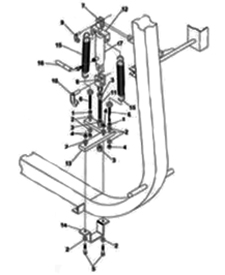 Hydraulic gate control drawing from operator's manual
Hydraulic gate control drawing from operator's manual

The hydraulic gate control kit is used to open and close the gate of the spreader without the operator having to get off the tractor by using the tractor's hydraulic system.
Rubber insert for discharge on pendular spreaders
The field-installed rubber insert kit is used to keep the discharge from clogging.
Features
Hopper
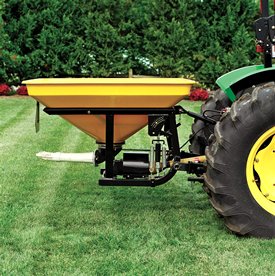 Anti-shock, reinforced fiberglass
Anti-shock, reinforced fiberglass
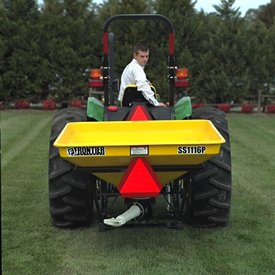 Corrosion resistant
Corrosion resistant
The reinforced fiberglass hopper on the 11 Series Pendular Spreader guarantees superior corrosion resistance, resulting in stronger durability and longer wear life.
The frame is made of sturdy, tubular steel and the hopper is painted with polyester resin powder coat for added corrosion resistance.
Spreader spout provides precision spreading
 Standard spout
Standard spout
Frontier™ Pendular Spreaders are designed to provide a precise spread. To accommodate this, they can be outfitted with various spreader spouts.
The spreader spouts are made of nylon and reinforced fiberglass for corrosion resistance and increased durability.
By simply rotating the optional directional spout's tip, an easy spread adjustment can be made to the left only, to the right only, or to the middle.
 Optional left/right directional attachment
Optional left/right directional attachment
 Optional left/right directional attachment
Optional left/right directional attachment
Drive system provides precision and strength
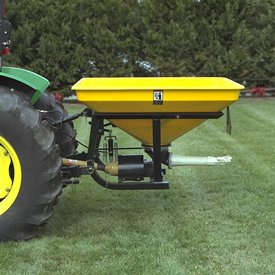 Drive system has anti-wear, cast-steel gearbox
Drive system has anti-wear, cast-steel gearbox
The SS11P Series Pendular Spreader comes standard with a 540-rpm power take-off (PTO), Category 1 driveline.
Its heavy-duty shielded shaft, made in compliance with American Society of Agricultural and Biological Engineers (ASABE) requirements, is built to last and ensures operator safety.
The anti-wear, cast-steel gearbox operates in an oil bath, providing a longer life and durability for the spreader.
Hydraulic gate control kit for SS10P, SS11P, and SS12P Series Pendular Spreaders
 Hydraulic gate control drawing from operator's manual
Hydraulic gate control drawing from operator's manual

The hydraulic gate control kit is used to open and close the gate of the spreader without the operator having to get off the tractor by using the tractor's hydraulic system.
Filter grate prevents damage to pendular spreaders
 Filter grate drawing from operator's manual
Filter grate drawing from operator's manual

The filter grate kit is used when loading SS1079P, SS1116P, SS1180P, and SS1220P Pendular Spreaders. It keeps hard and clumpy material from damaging parts or clogging the spreader.
Field-installed agitator kits for broadcast and pendular spreaders
All the field conversion agitator kits listed below allow operators to use multiple types of seed or fertilizer without clumping up.
Spout, deflector shields, and discharge kits for broadcast and pendular spreaders
Deflector shield conversion kits for broadcast spreaders ensure that material is thrown where the operator chooses.
Side-row discharge conversion kits for broadcast spreaders focus the spread to the side of the tractor.
The left-right direction attachment concentrates material to specific areas when using pendular spreaders.
A salt and sand spout kit and an optional locking nut are also available.
Rubber insert for discharge on pendular spreaders
The field-installed rubber insert kit is used to keep the discharge from clogging.
Features
Hopper
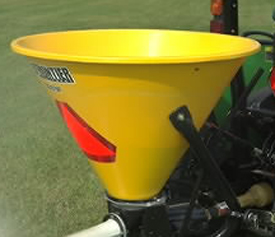 Hopper
Hopper

The reinforced fiberglass hopper on the 10 Series Pendular Spreader guarantees superior corrosion resistance, resulting in increased durability and longer wear life.
-
It comes complete with a frame made of sturdy, tubular steel and painted with polyester resin powder coat for added corrosion resistance.
Spreader spout provides precision spreading
 Standard spout
Standard spout
Frontier™ Pendular Spreaders are designed to provide a precise spread. To accommodate this, they can be outfitted with various spreader spouts.
The spreader spouts are made of nylon and reinforced fiberglass for corrosion resistance and increased durability.
By simply rotating the optional directional spout's tip, an easy spread adjustment can be made to the left only, to the right only, or to the middle.
 Optional left/right directional attachment
Optional left/right directional attachment
 Optional left/right directional attachment
Optional left/right directional attachment
Category 1 power take-off (PTO) driveline
 PTO driveline
PTO driveline
The 10 Series Pendular Spreader comes standard with a 540-rpm PTO, Category 1 driveline. Its heavy-duty shielded shaft, made in compliance with American Society of Agricultural and Biological Engineers (ASABE) requirements, is built to last and ensures operator safety.
The anti-wear, cast-steel gearbox operates in an oil bath, providing a longer life and durability for the driveline.
Hydraulic gate control kit for SS10P, SS11P, and SS12P Series Pendular Spreaders
 Hydraulic gate control drawing from operator's manual
Hydraulic gate control drawing from operator's manual

The hydraulic gate control kit is used to open and close the gate of the spreader without the operator having to get off the tractor by using the tractor's hydraulic system.
Filter grate prevents damage to pendular spreaders
 Filter grate drawing from operator's manual
Filter grate drawing from operator's manual

The filter grate kit is used when loading SS1079P, SS1116P, SS1180P, and SS1220P Pendular Spreaders. It keeps hard and clumpy material from damaging parts or clogging the spreader.
Field-installed agitator kits for broadcast and pendular spreaders
All the field conversion agitator kits listed below allow operators to use multiple types of seed or fertilizer without clumping up.
Hopper cover field conversion kits for broadcast and pendular spreaders
The hopper covers seal tightly around the containers so seed or fertilizer will not get wet or spill while in transport. Hopper covers are made of polyvinyl chloride (PVC).
The field conversion kits listed below are identified for the appropriate broadcast or pendular spreaders.
Spout, deflector shields, and discharge kits for broadcast and pendular spreaders
Deflector shield conversion kits for broadcast spreaders ensure that material is thrown where the operator chooses.
Side-row discharge conversion kits for broadcast spreaders focus the spread to the side of the tractor.
The left-right direction attachment concentrates material to specific areas when using pendular spreaders.
A salt and sand spout kit and an optional locking nut are also available.
Rubber insert for discharge on pendular spreaders
The field-installed rubber insert kit is used to keep the discharge from clogging.
Features
Hopper-enhanced technology provides long wear life
 Hopper
Hopper
Durability is a major component of the SS30B Broadcast Spreader hopper's polyethylene material. The hopper resists moisture and chemicals, allowing longer wear life even under the harshest weather conditions.
The standard fixed agitator and the seamless, conical hopper produces a quick, easy flow.
Power take-off (PTO) driven broadcast spreader
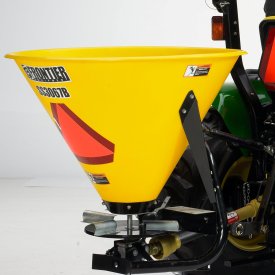 Close-up view
Close-up view
The SS30B Series Broadcast Spreader is PTO driven:
- Compatible with tractors ranging from 14.9 kW (20 hp) to 44.7 kW (60 hp)
- Equipped with 540-rpm PTO
Features
Hitching capabilities maximize operation time
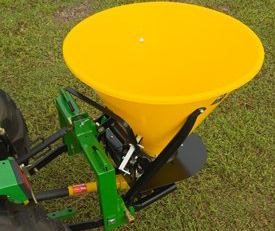 Compatible with 3-point hitch systems
Compatible with 3-point hitch systems
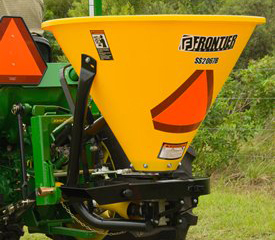 iMatch makes attachment time quick and easy
iMatch makes attachment time quick and easy
The SS20B Series Broadcast Spreaders are compatible with tractors featuring Category 0 (only SS1036B and SS2036B) and Category 1 3-point hitches.
The optional iMatch™ quick-htich compatibility (only SS1067B and SS2067B) makes attachment time quick and easy, maximizing operation time.
NOTE: If this option is chosen, the broadcast spreader must be specified to the factory as iMatch.
Hopper-enhanced technology ensures long wear life
 SS20B Series hopper
SS20B Series hopper
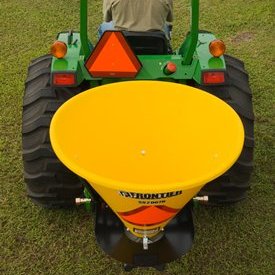 View into the hopper
View into the hopper
The Frontier™ SS20B Series Broadcast Spreader hopper’s polyethylene material resists moisture and chemicals, allowing longer wear life even under the harshest weather conditions:
- A seamless, conical hopper produces a quick, easy flow.
- Plastic hopper and stainless-steel internal components are chemical and water resistant.
- Standard fixed agitator stationed inside the hopper aids product down to the gate opening.
Power take-off (PTO) driven broadcast spreaders
 Broadcast spreaders are PTO driven
Broadcast spreaders are PTO driven
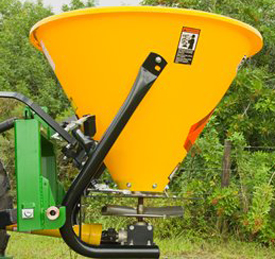 Close-up view
Close-up view
The SS10B and SS20B Series Broadcast Spreaders are both PTO driven:
-
Compatible with tractors ranging from 11.9 kW (16 hp) to 41 kW (55 hp)
-
Equipped with 540-rpm PTO and a sealed, heavy-duty gearbox containing extreme pressure (EP) grade grease.
Swath control levers available to accommodate various tasks
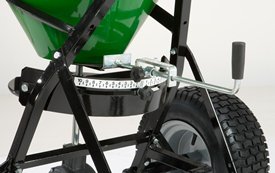 Ground-driven controls
Ground-driven controls

Different swath spread patterns are available so the broadcast spreader can accommodate various tasks with precision and efficiency.
All broadcast spreaders allow three different swath spread patterns:
- Predominantly left
- Predominantly right
- Left to right
Field-installed agitator kits for broadcast and pendular spreaders
All the field conversion agitator kits listed below allow operators to use multiple types of seed or fertilizer without clumping up.
Hopper cover field conversion kits for broadcast and pendular spreaders
The hopper covers seal tightly around the containers so seed or fertilizer will not get wet or spill while in transport. Hopper covers are made of polyvinyl chloride (PVC).
The field conversion kits listed below are identified for the appropriate broadcast or pendular spreaders.
Spout, deflector shields, and discharge kits for broadcast and pendular spreaders
Deflector shield conversion kits for broadcast spreaders ensure that material is thrown where the operator chooses.
Side-row discharge conversion kits for broadcast spreaders focus the spread to the side of the tractor.
The left-right direction attachment concentrates material to specific areas when using pendular spreaders.
A salt and sand spout kit and an optional locking nut are also available.
Field-installed remote gate kit for broadcast spreaders
The field-installed remote gate kit allows the operator to easily engage the spreader from the seat without having to dismount the tractor.
Features
Hopper strong enough for rough handling and heavy use
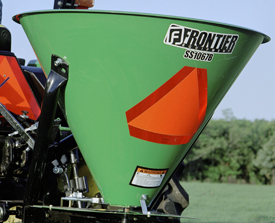 All-steel hopper endures rough and heavy use
All-steel hopper endures rough and heavy use
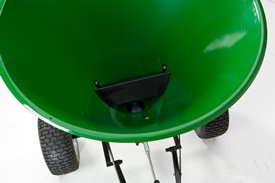 Inside view of SS10B Series Hopper
Inside view of SS10B Series Hopper
The one-piece, seamless, all-steel hoppers are strong enough to endure rough handling and heavy use.
Hitching capabilities maximize operation time
 Compatible with 3-point hitch systems
Compatible with 3-point hitch systems
 iMatch makes attachment time quick and easy
iMatch makes attachment time quick and easy
The SS20B Series Broadcast Spreaders are compatible with tractors featuring Category 0 (only SS1036B and SS2036B) and Category 1 3-point hitches.
The optional iMatch™ quick-htich compatibility (only SS1067B and SS2067B) makes attachment time quick and easy, maximizing operation time.
NOTE: If this option is chosen, the broadcast spreader must be specified to the factory as iMatch.
Power take-off (PTO) driven broadcast spreaders
 Broadcast spreaders are PTO driven
Broadcast spreaders are PTO driven
 Close-up view
Close-up view
The SS10B and SS20B Series Broadcast Spreaders are both PTO driven:
-
Compatible with tractors ranging from 11.9 kW (16 hp) to 41 kW (55 hp)
-
Equipped with 540-rpm PTO and a sealed, heavy-duty gearbox containing extreme pressure (EP) grade grease.
Swath control levers available to accommodate various tasks
 Ground-driven controls
Ground-driven controls

Different swath spread patterns are available so the broadcast spreader can accommodate various tasks with precision and efficiency.
All broadcast spreaders allow three different swath spread patterns:
- Predominantly left
- Predominantly right
- Left to right
Field-installed agitator kits for broadcast and pendular spreaders
All the field conversion agitator kits listed below allow operators to use multiple types of seed or fertilizer without clumping up.
Hopper cover field conversion kits for broadcast and pendular spreaders
The hopper covers seal tightly around the containers so seed or fertilizer will not get wet or spill while in transport. Hopper covers are made of polyvinyl chloride (PVC).
The field conversion kits listed below are identified for the appropriate broadcast or pendular spreaders.
Spout, deflector shields, and discharge kits for broadcast and pendular spreaders
Deflector shield conversion kits for broadcast spreaders ensure that material is thrown where the operator chooses.
Side-row discharge conversion kits for broadcast spreaders focus the spread to the side of the tractor.
The left-right direction attachment concentrates material to specific areas when using pendular spreaders.
A salt and sand spout kit and an optional locking nut are also available.
Field-installed remote gate kit for broadcast spreaders
The field-installed remote gate kit allows the operator to easily engage the spreader from the seat without having to dismount the tractor.
Features
Aerator rotor
 Straight blades provide one-step dual functions
Straight blades provide one-step dual functions
The TR2058 Overseeder has a straight blade aerator rotor that aerates the soil and incorporates the seed all in one step.
Rear cultipacker
 Firms and smoothes the turf
Firms and smoothes the turf
The TR2058 Overseeder has rear cultipacker rings that compact and level the turf to ensure successful germination.
Front gauge roller
 Levels ground and controls seed depth
Levels ground and controls seed depth
By adding the front gauge roller onto the TR2058 Overseeder, the operator can level the ground and control the seed depth. This is recommended for rental operations.
NOTE: Gauge wheels and the front roller cannot be used together.
Scraper bar
 Optional scraper bar
Optional scraper bar
The optional scraper bar on the TR2058 Overseeder is ideal for clay or wet conditions.
C-blade tiller
 C-blade tiller creates versatility
C-blade tiller creates versatility
By simply unbolting the double flanges at each end of the aeration rotor, operators can install the optional tiller rotor. This transforms the TR2058 Overseeder Aerator into a primary seedbed preparation machine.
Field-installed gauge wheel kit for TR2058 Overseeder
The field conversion gauge wheel kit for the TR2058 Overseeder includes two wheels and arms that can be set to ride on the wheels, so when lowered, they prevent the overseeder from lowering too far.
Front roller, tilling roller, and rear roller scraper field-conversion kits for TR2058 Overseeder
The first attachment is a field-installed front roller kit to compact soil for the aeration rotor.
The second attachment is a field-installed tilling roller kit to assist in preparing new seedbeds.
The third attachment is a rear roller scraper to keep material from kicking over the backside of the roller, leaving a smooth, finished job.
Features
Front spiked rollers
 Front spiked rollers
Front spiked rollers
The GS11 Series Overseeder has spiked front rollers. When the front rollers are straight, the large front pins will penetrate the soil in a straight pushing action and little disturbance is caused to the turf. Angle the front roller for more aggressive tearing action.
Three seed box options
 Seed boxes
Seed boxes
The GS11 Series Overseeder has three seed boxes that can be used for cool season, warm season, and legumes, letting operators plant anything from rye and oats to prairie grasses, wild flowers, radishes, and soybeans.
Calibration tray
 Calibration tray
Calibration tray
Calibration tray system is used to assist in adjusting the seed cups for the desired seeding rate. The calibration tray can be used with the overseeder in the stationary position or pulled over a short distance to the seedbed.
Front disc
 Front disc
Front disc
The front disc option on the GS11 Series Overseeder can be used to prepare a seedbed without the need for a separate disc or tillage tool used ahead of time.
Rear drive roller
 Rear drive roller
Rear drive roller
The rear drive roller firms and presses soil kicked up by the front tillage tool. This creates a uniform seedbed with loose soil necessary for ensuring proper seed germination.
Scraper bar
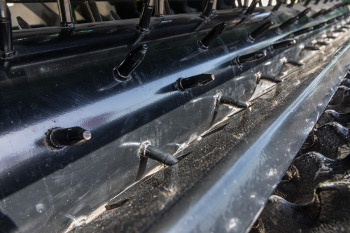 Optional scraper bar
Optional scraper bar
The optional scraper bar on the GS11 Series Overseeder is ideal for clay or wet conditions.
Rear cultipacker
 Firms and smooths the turf
Firms and smooths the turf
The GS11 Series Overseeder has rear cultipacker rings that compact and level the turf to ensure successful germination.
Features
Minimize soil disturbance with front spiked rollers
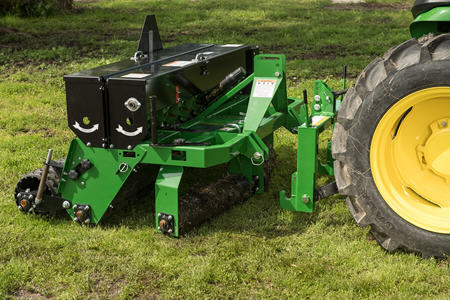 Front spiked rollers
Front spiked rollers
The GS10L Series Light-Duty Overseeder features spiked front rollers. When front rollers are set straight, the large front pins will penetrate the soil in a straight pushing action causing little soil and turf disturbance. Angle the front roller for more aggressive tilling action.
Added versatility with two seed box options
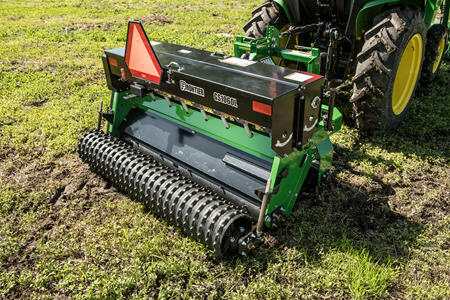 Seed boxes
Seed boxes
The GS10L Series Light-Duty Overseeder has two seed box options that can be used for cool season and legumes. The cool season seed box lets operators plant anything from rye grass and fescue to orchard grass, while the legume box can be used for seeds such as alfalfa, Bermuda, and clover.
Optimize seeding process with the calibration tray
 Calibration tray
Calibration tray
A calibration tray system catches seed used to calibrate seed meters and adjusts desired seeding rate. The calibration tray can be used with the overseeder in the stationary position or pulled over a short distance in the seedbed.
Increase efficiency with the front disc
 Front disc
Front disc
The front disc option on the GS10L Series Light-Duty Overseeder can be used to prepare a seedbed, reducing the need for a tillage tool and increasing working efficiency.
Smooth the seedbed with the rear drive roller
 Rear drive roller
Rear drive roller
The rear drive roller doubles as a seed meter chain drive and firms and presses soil kicked up by the front tillage tool. This creates a smooth seedbed all while accurately dispersing seed in proportion to ground speed.
Work in difficult soil conditions using the scraper bar
 Optional scraper bar
Optional scraper bar
The optional scraper bar on the GS10L Series Light-Duty Overseeder is ideal for wet or sticky soil conditions.
Improve seed germination with rear cultipacker
 Rear cultipacker firms and smooths the turf
Rear cultipacker firms and smooths the turf
The GS10L Series Light-Duty Overseeder has an optional rear cultipacker that levels and breaks soil clods and presses the seed into the soil for improved seed-to-soil contact and increased germination.
Features
Seedboxes available in multiple configurations
 Multiple seedbox configurations
Multiple seedbox configurations

Available in multiple options, the CS Series seedboxes can be ordered to best suit the producer's requirements. Up to four configurations are available:
- Standard large-grain box
- Native grass box
- Small-seed legume box
- Fertilizer box
Seedboxes can also be disengaged to perform soil aeration and dethatching.
Accurately control the ground speed with ground-driven spiked rollers
 Spiked rollers for perfect seed-to-soil contact
Spiked rollers for perfect seed-to-soil contact

The CS Series Seeders are ground driven with the front rollers aggressively turning the back roller 40 percent faster. This allows the operator to more accurately control the ground speed at which they travel.
Frontier™ conservation seeders gently till the ground and create the perfect seedbed for new seeding jobs, while also allowing the operator to seed into existing grass and pasture.
Rear cultipacker ensures good seed-to-soil contact
 Rear cultipacker firms and smoothes seedbed
Rear cultipacker firms and smoothes seedbed

Rear cultipacker rings compact and level the seedbed, ensuring good seed-to-soil contact. They are available in two choices:
- Corrugated reinforced nylon
- Cast iron
An exclusive torque arm helps maintain a constant adjustable down pressure on the rear of the cultipacker.
Features
Optional furrow boots
Double-disk openers with aluminum boots work well in well-prepared seedbeds and dry soil. Blades bolt on to allow use of a broad range of depth-gauging attachments.
Double-disk openers with cast-iron boots are also available. They are heavier and have greater clearance inside of double-disk openers for better performance in wet, sticky soils.
Boot |
Opener weight |
Spring down pressure* |
Total penetration force |
||
|
|
Minimum |
Maximum |
Minimum |
Maximum |
Aluminum |
10.4 kg (23 lb) |
11.3 kg (25 lb) |
43.1 kg (95 lb) |
21.8 kg (48 lb) |
53.5 kg (118 lb) |
Cast iron |
12.7 kg (28 lb) |
11.3 kg (25 lb) |
43.1 kg (95 lb) |
24 kg (53 lb) |
56.2 kg (124 lb) |
*NOTE: The down pressure figures are based on 25.4 mm (1 in.) of push rod showing above spring.
Seed/fertilizer meter drive system
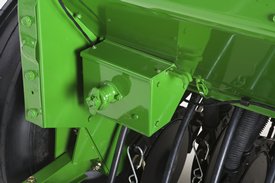 BD11 fertilizer metering system
BD11 fertilizer metering system

The seed and fertilizer metering systems are powered by the end wheel. A heavy-duty, high-strength No. 40 roller chain provides a positive drive. Spur gears and sprockets are machined to provide a more accurate fit for longer life. Gears can be interchanged for either a slow or fast speed.
Half-speed drive for fluted feed drills
The half-speed drive reduces the feed shaft speed by one-half, which allows for the very low seed rates required for crops such as rape and sorghum. It also permits higher seed index settings for large seeds such as soybeans. The resulting greater flute exposure reduces seed damage sometimes caused by forcing seeds through the opening between the shutoff and feed cup housing.
Field-installed agitator kits for BD11 and BD13 Grain Drills
Add a field-installed agitator to keep light, fluffy, odd-shaped, or inoculated seed feeding smoothly into meters.
The first three attachments listed are for BD11 Series End-Wheel Grain Drills.
The fourth attachment is for the BD1307 No-Till Grain Drill.
Depth band field conversion kits for cast-iron boots on grain drills
Depth band field conversion kits for the cast-iron boots offer cost-effective depth control.
The first attachment is for the BD1307 No-Till Grain Drill.
The last two attachments are for BD11 Series End-Wheel Grain Drills and include scrapers to use for planting 5.1-cm (2-in.) deep.
Double-disk opener boot kits and outside scrapers kits for BD11 Series End-Wheel Grain Drills
Choose aluminum boots for prepared seedbeds and dry soil. They provide up to 53.5 kg (118 lb) of down pressure.
Cast-iron boots deliver as much as 56.2 kg (124 lb) of down pressure, making them ideal for wet, sticky conditions.
The field conversion kit for a double-disk outside scraper kit comes with 10 pairs. They are designed to scour/remove soil and residue from the furrow opener and are recommended for use in damp, sticky soil conditions.
- Producers must also order outside scraper parts (option code 9050) if used in combination with depth-gauging press wheels.
- Not compatible with Tru-Vee attachment.
The field conversion kit for outside scraper parts comes with 26 pairs.
- This kit is required on drills with depth-gauging press wheels and a double disk.
Field-installed adjustable depth gauge wheel kit for BD11 Series End-Wheel Grain Drills
Adjustable depth gauge wheels are for double-disk openers with an aluminum boot. The adjustable depth gauge wheel mounts to the double-disk opener at one side and firms one furrow wall, preventing soil from crumbling into the furrow.
Two tines scratch along the furrow walls, drawing the soil over the seed. It gauges the depth of the furrow from 1.3 cm (0.5 in.) to 8.9 cm (3.5 in.) and is for 19.1-cm (7.5-in.) or 25.4-cm (10-in.) row spacing.
NOTE: The kit does not include opener.
Depth gauge press wheel kits for BD11 Series End-Wheel Grain Drills
 Depth gauge press wheels for better seedbed
Depth gauge press wheels for better seedbed

Depth-gauging press wheels assist in controlling furrow depth and promote seed-to-soil contact for good germination.
Press wheels have smooth sides to reduce soil throw and leave a better-looking seedbed.
 1x12 press wheel
1x12 press wheel
 2x13 press wheel
2x13 press wheel
 4x12 double-rib press wheel
4x12 double-rib press wheel
A variety of sizes and types are available to match seed-to-soil contact requirements. Available wheels are:
- 2.5-cm x 30.5-cm (1-in. x 12-in.) single
- 5.1-cm x 33-cm (2-in. x 13-in.) single
- 10.2-cm x 30.5-cm (4-in. x 12-in.) double-rib
Tru-Vee attachment field conversion kit for BD11 Series End-Wheel Grain Drills
The Tru-Vee attachment field conversion kit gives operators planter-type depth control.
Grass seedbox field attachment kits for BD11 Series End-Wheel Grain Drills
A variety of grass seed attachments are available for the BD11 Series End-Wheel Grain Drills, providing accurate and dependable fluted force feed. They are also capable of handling the smallest seed accurately.
Field-installed cover chain kit for BD11 Series End-Wheel Grain Drills
This kit includes a quantity of 10 cover chains to ensure adequate seed coverage. They can be used with single-disk or double-disk openers with or without fertilizer tubes.
Features
Versatile machine configurations
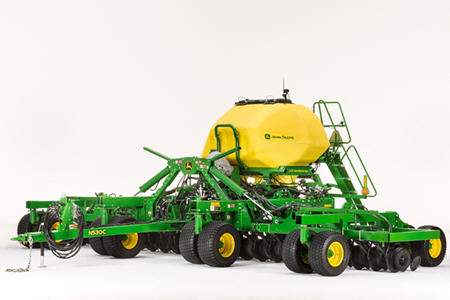 N500C with SeedMetering2
N500C with SeedMetering2
 N500C in the field
N500C in the field
The N500C is designed for no-till seeding. The N500C with SeedMetering2 offers accurate volumetric metering in a compact tank-mounted-on-frame design, with the convenience of the Central Commodity System (CCS™) bulk-fill capabilities.
The N500C is available in single- or dual-rank designs, with 9.15-m, 11-m, 12.2-m, and 12.8-m (30-ft, 36-ft, 40-ft, and 42-ft) working widths. The single-rank N500C is available in 38.1-cm (15-in.) row spacing, making for a highly productive soybean seeding machine, while the dual-rank models are available in 19-cm or 25.4-cm (7.5-in. or 10-in.) row spacings. The dual-rank models also feature an optional dual row spacing package, which allows them to seed in their standard spacing or lock-up one rank and seed in 38.1-cm or 50.8-cm (15-in. or 20-in.) row spacings.
The productivity of the CCS comes standard with the N500C. The CCS bulk-fill tanks feature 3523.9-L (100-bu) capacity on the 9.15-m (30-ft) to 11-m (36-ft) models. The 12.2-m (40-ft) and 12.8-m (42-ft) models offer 4228.7 L (120 bu) of capacity to allow operators to seed more acres before stopping to refill.
The N500C features the Pro-Series™ No-Till Openers. With well over one million no-till openers in the field today, this proven opener offers accurate seed placement with the exclusive active hydraulic downforce ground-following system while minimizing moisture loss with its low-disturbance opener design.
Improved meter access with new frame design
The tank on the N500C has been moved up and back to allow for better access to the meters. The blower fan has been relocated to the front of the tank to allow non-obstructed access to all four meters.
 Rear of N500C machine
Rear of N500C machine
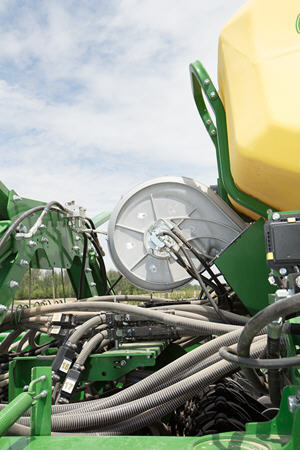 Relocated blower fan
Relocated blower fan
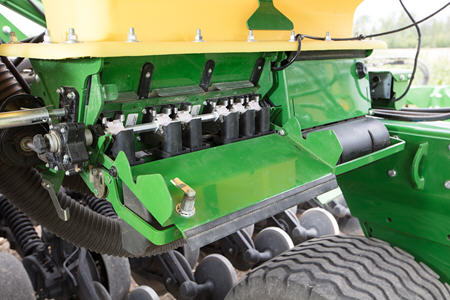 Easy meter access
Easy meter access
The updated tank design is also larger. The 9.15-m (30-ft) to 11-m (36-ft) models offer a 3523.9 -L (100-bu) tank. The 12.2-m (40-ft) and 12.8-m (42-ft) models offer a 4228.7-L (120-bu) tank.
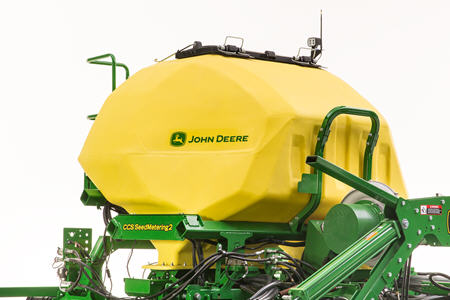 3523.9-L (100-bu) tank
3523.9-L (100-bu) tank
Tank cleanout has also been improved. Producers can place a seed box or conveyer under the tanks to empty out excess seed. The tank has been designed so there is minimal seed left in the tank after it has been emptied.
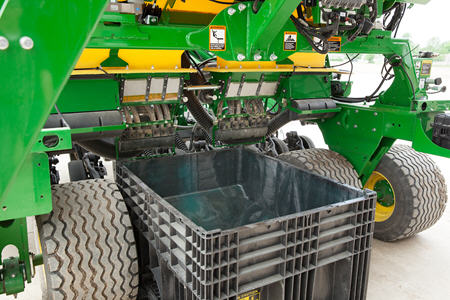 Cleanout with a seed box
Cleanout with a seed box
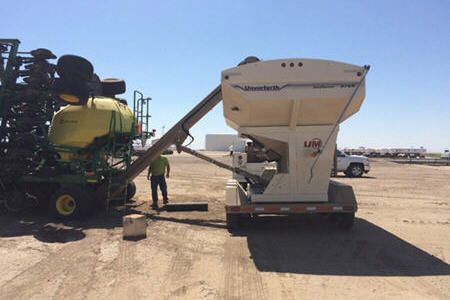 Cleanout with seed tender
Cleanout with seed tender
Calibrating the meters has also been improved thanks to electric drive metering. The N500C is calibrated stationary similar to larger air carts. Catch bags are placed under each meter, and the meters turn a pre-determined amount of revolutions. Catch bags are weighted and entered into the SeedPlus app or on the Gen 4 display in order to generate a meter displacement value (MDV).
 Calibrating the meters
Calibrating the meters
High floatation tires
The N500C offers 33x15.5R16.5 tires standard on all machines, resulting in better floatation and less compaction and allowing operators to get into the field sooner and stay in the field longer. The mainframe is also equipped with walking beams to allow for better ground following.
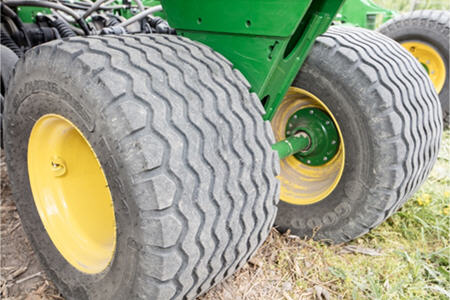 500/40R16.5 tires with walking beam
500/40R16.5 tires with walking beam
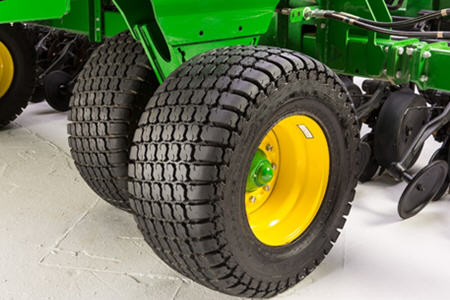 33x15.5R16.5 tires with walking beam
33x15.5R16.5 tires with walking beam
 31x13.5R15 tires on wing frame
31x13.5R15 tires on wing frame
| Option code | Width | Mainframe front tire size | Number of tires | Mainframe rear tire size | Number of tires | Wing frame tire size | Number of tires |
| 3610 | All | 33x15.5R16.5 | 4 | 33x15.5R16.5 | 4 | 31x13.5R15 | 4 |
| 3611 | All | 33x15.5R16.5 | 4 | 33x15.5R16.5 | 4 | 31x13.5R15 | 8 |
| 3612 | 9.5/11-m (30/36-ft) |
33x15.5R16.5 | 4 | 500/40R16.5 | 4 | 33x15.5R16.5 | 8 |
| 3613 | 12.2/12.8-m (40/42-ft) |
500/40R16.5 | 4 | 500/40R16.5 | 4 | 33x15.5R16.5 | 8 |
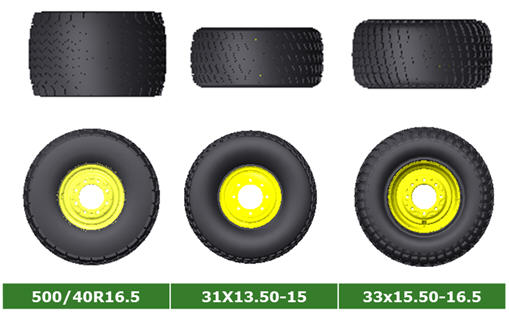 Tire area comparison
Tire area comparison
Electric drives enabling SectionCommand™ system
For the first time, meter sections are controlled with electric motors. Each meter section has its own electric drive motor. This eliminates the need for a variable-rate drive hydraulic motor or a ground drive wheel. This also enables the SectionCommand system and variable/prescription seeding.
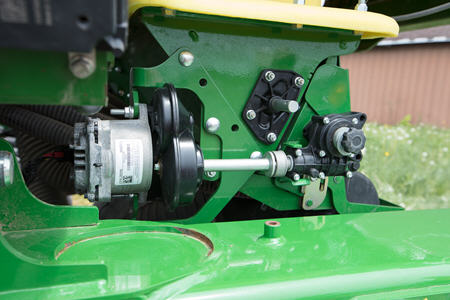 Electric drive motor on meter
Electric drive motor on meter
 SeedStar run page showing four sections and prescription (Rx) seeding
SeedStar run page showing four sections and prescription (Rx) seeding
Perscription/variable-rate seeding allows growers to apply the right amount of seed depending on predetermined management zones. Four-section SectionCommand has shown a potential seed savings of 4 to 6 percent depending on field size and shape.
Power generation
The electric motors are powered by a power take-off (PTO) power generation unit or an onboard hydraulic power generator. Growers can choose either of these options based on their tractor limitations. The on-board system utilizes power beyond, whereas the PTO system frees up hydraulic capacity on the tractor as the PTO powers the generator.
 PTO power generation unit
PTO power generation unit
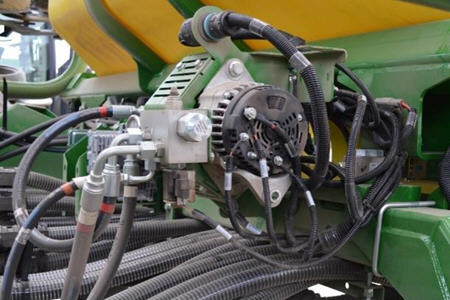 On-board power generation unit
On-board power generation unit
John Deere ActiveCal™ system
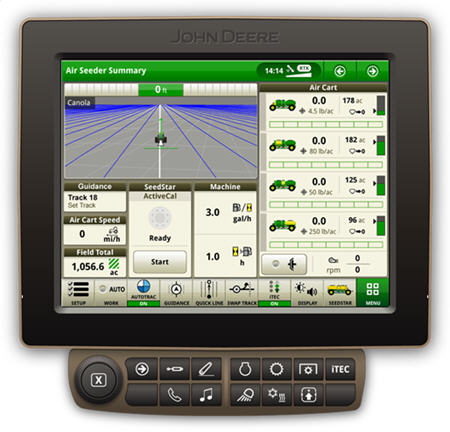 ActiveCal initiated on a C850
ActiveCal initiated on a C850
 ActiveCal initiated on an N500C
ActiveCal initiated on an N500C
The more frequently calibration is completed, the more accurate a seeder will be. A number of variables, including product weight and changing climate conditions throughout the day, will have an effect on any volumetric metering system; with the John Deere ActiveCal system, calibration can be done from the cab of the tractor, while seeding, to minimize the variation in product metering.
The process to calibrate the implement starts with the Gen 4 4600 CommandCenter™ Display in the work setup page, where the operator defines product types, rates and selects meter rollers. Based on information entered into the work setup page, a preconfigured meter displacement value (MDV) will populate per meter. An initial manual calibration will give the most accurate MDV to start with. However, the preconfigured MDV will be a good starting point for growers who do not wish to manually calibrate.
The operator engages ActiveCal while stationary by selecting the button on the screen and then begins seeding. When enough product has been metered out, typically after about 8-12 acres, the Gen 4 CommandCenter will prompt the operator to stop when convenient to do so. At that time, the data points are calculated and a new MDV with percent difference is displayed on screen. The operator can accept or reject the new MDV. If accepted, the system automatically calibrates to the new MDV. If rejected, the system continues at the previously calibrated numbers.
 Tank scales provide tank weights to ActiveCal system
Tank scales provide tank weights to ActiveCal system
RelativeFlow™ Blockage sensing
 RelativeFlow blockage sensing
RelativeFlow blockage sensing
With the RelativeFlow blockage system, operators can see the flow rate of both seed and fertilizer from inside the tractor cab. Sensors on delivery hoses monitor the relative rate of product flow. An easy-to-read display clearly visualizes relative product flow across the drill, from opener to opener. This exclusive technology gives a better view of what is happening across the tool in order to spot problems before blockage occurs.
RelativeFlow Blockage is available on the following models:
- P540 - 12.2-m (40-ft)
- P556 - 17.1-m (56-ft)
- P576 - 23.2-m (76-ft)
- N500C - all widths
- 1890 - 15.2-m (50-ft) and 18.3-m (60-ft)
- N530F - 9.1-m (30-ft)
- N540F - 12.2-m (40-ft)
- N543F - 13.1-m (43-ft)
- N560F - 18.3-m (60-ft)
Below are the GreenStar™ 3 2630 Display screens for the blockage monitoring system. For complete details and information, see the owner’s manual.
 Blockage monitoring screen
Blockage monitoring screen
The RelativeFlow system chart shows the amount of flow through each sensor on the selected tower. Sensitivity for the blockage system can be adjusted if desired, as shown below.
 Blockage set-up screen
Blockage set-up screen
Blockage warning sensitivity allows the producer to set and change the sensitivity of the sensors to meet their preferences. Increasing the sensitivity means the system is more likely to show a false blockage, while less sensitivity means the system is more likely to miss a blockage.
Multiple run-page alarm behavior options are available for selection.
 Blockage set-up screen
Blockage set-up screen
Below are the Gen 4 display screens for the blockage monitoring system on the N500C.
For complete details and information reference, the owner’s manual.
 RelativeFlow Blockage configured run page
RelativeFlow Blockage configured run page
The SeedStar™ system run page displays the five major run settings. Clicking on any of the tiles will take an operator to that specific page (shown below).
 Operators can zoom into flow details by meter section when selecting Blockage tiles
Operators can zoom into flow details by meter section when selecting Blockage tiles
 Operators can zoom into the row level to access row/sensor information and turn a sensor on/off independently
Operators can zoom into the row level to access row/sensor information and turn a sensor on/off independently
 Blockage sensitivities and alarm delays are all set up on one easy-to-navigate screen
Blockage sensitivities and alarm delays are all set up on one easy-to-navigate screen
Blockage alarm delays can be set up by clicking on the advanced settings button from the blockage set-up screen.
- A blockage delay is how long a blockage should occur before an alarm is sounded.
- The blockage alarm reminder is how often the alarm should sound when a blockage occurs.
- The meter on delay is the time from when the meter is turned on until the blockage sensor should start monitoring for blockage.
- The meter off delay is the time from when the meter is turned off until the blockage sensor should start monitoring to verify no flow.
For more detailed information, see the owner’s manual.
Air tools with Relative Flow Blockage are not compatible with 1910 air carts with ground drive.
TruSet™ downforce system
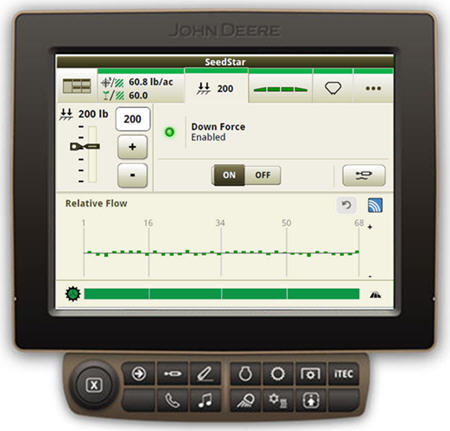 Downforce control from the Gen 4 display
Downforce control from the Gen 4 display
TruSet downforce allows operators to set downforce pressures from inside the cab. Downforce can easily be changed by the push of a button as soil conditions very. Proper downforce is directly related to a consistent seeding depth, which leads to improved even emergence, plant density, and maturity.
TruSet system quick-reference guide
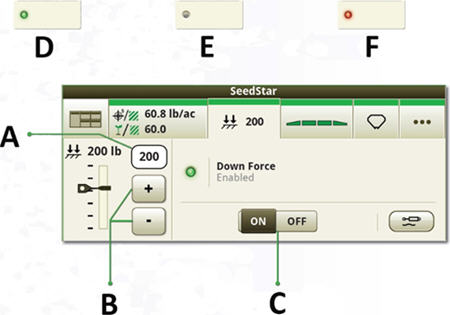
TruSet downforce settings:
A. Select to manually input a value
B. Select to increase or decrease the target force of the openers
C. Downforce toggle button: select to enable or disable the downforce
D. Indicates that the downforce is enabled
E. Indicates that the downforce is disabled
F. Indicates that the downforce is enabled but not applying
SeedPlus™ mobile app
 SeedPlus app homescreen
SeedPlus app homescreen
Tank scale weights and meter calibrations can be completed from an Android™ or iOS® mobile device anywhere around the machine.
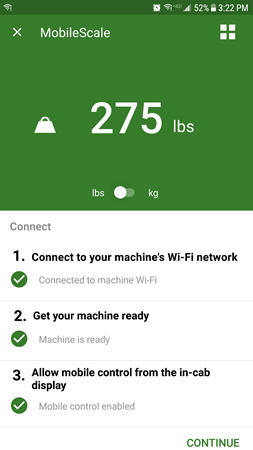 Calibrating tank scales
Calibrating tank scales
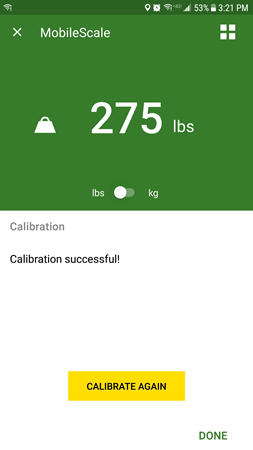 Calibration complete
Calibration complete
Tank scale weights can be viewed anywhere within 15.2 m (50 ft). The SeedPlus app can also be used to calibrate the tank scales as needed.
Initial meter calibration
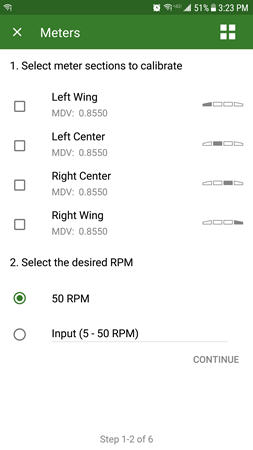 Select meters to calibrate
Select meters to calibrate
Select the meters that toned to be calibrated. Calibrations are recommended every morning or when crops/seed sizes are changed.
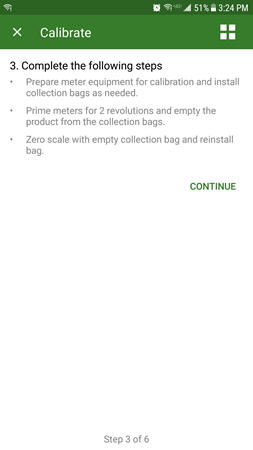 Steps to complete calibration
Steps to complete calibration
Follow the on-screen prompts to complete the calibration.
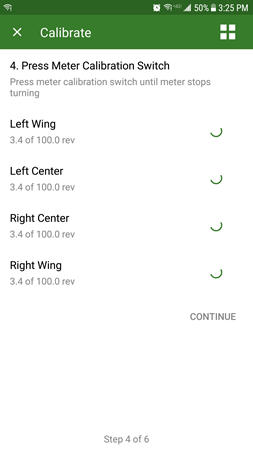 Press meter calibration switch
Press meter calibration switch
Once the catch bags are in place, hold down the meter calibration switch until the number of revolutions is complete.
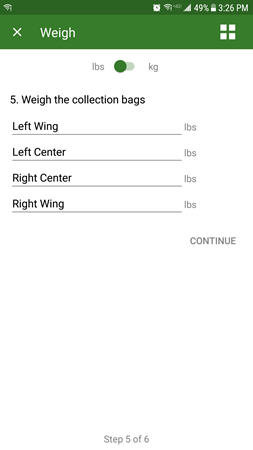 Weights of bag for each meter
Weights of bag for each meter
 Entering the weight of the bags
Entering the weight of the bags
Enter the weights of the bags into the app.
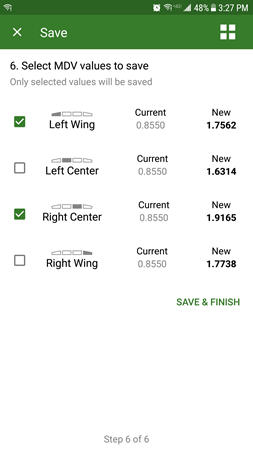 Save meter displacement values (MDV)
Save meter displacement values (MDV)
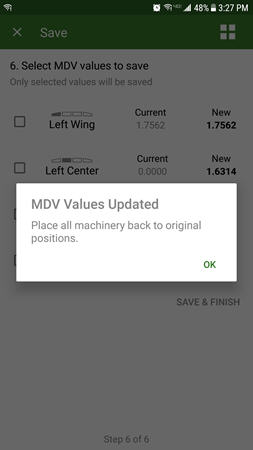 MDV values are updated
MDV values are updated
The SeedPlus app will calculate MDV based on the number of revolutions and the product weights. Operators can choose to accept the proposed MDV values or not.
Android is a trademark of Google LLC. iOS is a trademark of Cisco Technology, Inc. used under license by Apple Inc.
Generation 4 Display compatibility
This document lists all the compatible equipment approved with the software update 19-2 release, and is subject to change with newer software updates. To ensure complete and proper compatibility, the most current version of implement control unit software, Generation 4 Display software, or compatible farm management information software (FMIS) should be used. Non-current software versions will require an update before support can be provided. Unapproved software version configurations will not be supported.
The software update 19-2 release is only compatible with 4600 CommandCenter™ v2 processors. Software update 17-2 is the last release that was compatible with 4600 v1 processors.
Server serial numbers are as follows:
- v1 = RWG prefix
- v2 = PCG prefix
Machine compatibility
John Deere Large Ag Tractors
| John Deere Large Ag Tractors (list of all automatically detected machines) |
Model year | CommandCenter display | Universal Display | ||
| 4600 v2 | 4200 | 4640 | 4240 | ||
| 9R/9RT/9RX Series | 2018 and newer | X | --- | X | X |
| 9R/9RT/9RX Series | 2015-2017 | * | --- | X | X |
| 9R/9RT Series | 2012-2014 | --- | --- | X | X |
| 9030/9030T Series | 2008 and newer | --- | --- | X | X |
| 9020/9020T Series | 2002-2007 | --- | --- | X | --- |
| 9000 Series | 1997-2001 | --- | --- | X | --- |
| 9000T Series | 2000-2001 | --- | --- | X | --- |
| 8R/8RT Series | 2018 and newer | X | --- | X | X |
| 8R/8RT Series | Mid-2014 - 2017 | * | --- | X | X |
| 8R/8RT Series | 2010-2013 | --- | --- | X | X |
| 8030/8030T Series | 2006 and newer | --- | --- | X | X |
| 8020/8020T Series | 2002-2005 | --- | --- | X | --- |
| 8010/8010T Series | 2000-2002 | --- | --- | X | --- |
| 8000 Series | 1994 | --- | --- | X | --- |
| 8000T Series | 1997-1999 | --- | --- | X | --- |
| 7R Series | 2018 and newer | X | X | X | X |
| 7R Series | 2014-2017 | * | --- | X | X |
| 7R Series | 2011-2013 | --- | --- | X | X |
| 7J Series | 2018 and newer | --- | --- | X | X |
| 7030 Series | 2007 and newer | --- | --- | X | X |
| 7030 Series (Large Frame) | 2007 and newer | --- | --- | X | X |
| 7030 Series (Small Frame) | 2006 and newer | --- | --- | X | X |
| 7010 Series | 1997-2003 | --- | --- | X | --- |
| 7000 Series | 1992-1996 | --- | --- | X | --- |
| 6030 Series (Small Frame) | 2006 and newer | --- | --- | X | X |
| 6000 Series | 1992-1998 | --- | --- | X | --- |
| 6010 Series | 1999-2002 | --- | --- | X | --- |
| 6R Series | 2018 and newer | X | X | X | X |
| 6R Series (Final Tier 4) | 2015-2017 | * | --- | X | X |
| 6R Series (Interim Tier 4) | 2013-2015 | --- | --- | X | X |
| 6M Series | 2013 and newer | --- | --- | X | X |
| 6J Series | 2018 and newer | --- | --- | X | X |
| 5R Series | 2019 and newer | --- | --- | X | X |
*NOTE: For latest Precision Ag functionality, update machines equipped from the factory with v1 processor to v2. The 4640 Universal Display is not compatible with SeedStar™ 4HP Planters when installed on 00, 10, and 20 Series Tractors.
John Deere Nutrient Applicators
John Deere Nutrient Applicators |
Model year | CommandCenter | Universal Display | ||
| 4600 v2 | 4200 | 4640 | 4240 | ||
| F4365 High-Capacity Nutrient Applicator | 2017 and newer | X | --- | --- | --- |
John Deere Self-Propelled Sprayers
| John Deere self- propelled sprayers |
Model year | CommandCenter | Universal Display | ||
| 4600 v2 | 4200 | 4640 | 4240 | ||
| 4 Series Sprayers | 2018 and newer | X | --- | --- | --- |
| 4 Series Sprayers | 2013 - 2017 | --- | --- | X | --- |
| 4940 | 2012 - 2014 | --- | --- | X | --- |
| 4630 | 2008 and newer | --- | --- | X | --- |
| 4730 | 2008 and newer | --- | --- | X | --- |
| 4830 | 2008 - 2014 | --- | --- | X | --- |
| 4930 | 2008 - 2013 (SN 4000+) | --- | --- | X | --- |
| R4040i | 2014 and newer | --- | --- | X | --- |
| R4050i | 2017 and newer | --- | --- | X | --- |
| 5430i | 2008 - 2014 | --- | --- | X | --- |
| Hagie™ sprayers | 2014 and newer | Compatible with GreenStar™ 3 2630 Displays and 4640 Universal Displays* | |||
*NOTE: When using the 4640 Universal Display on a Hagie Sprayer, additional mounting and harnessing may be required.
- 4640 Ram™ Mount - SJ34503
- 4640 power/video harness - BPF11527 (1-3 video plus machine power), PF90687 (machine power only)
NOTE: Current John Deere/Hagie field kits only offer GreenStar 3 2630 Display parts.
NOTE: AutoTrac™ Vision/AutoTrac RowSense and multi-rank section control are not supported on Hagie at this time.
NOTE: VIN detection is not supported on Hagie Sprayers at this time.
John Deere Self-Propelled Forage Harvesters (SPFH)
John Deere Self-Propelled |
Model year | CommandCenter | Universal Display | ||
| 4600 v2 | 4200 | 4640 | 4240 | ||
| 9000 Series SPFH | 2019 and newer | --- | --- | X | --- |
| 8000 Series SPFH | 2015 and newer | --- | --- | X | --- |
John Deere combines
| John Deere combines | Model year | CommandCenter | Universal Display | ||
| 4600 v2 | 4200 | 4640 | 4240 | ||
| S700 Series | 2018 and newer | X | --- | --- | --- |
| S430 and S440 | 2017 and newer | X | --- | --- | --- |
| S600 Series | 2012 - 2017 | --- | --- | X | X |
| S540 and S550 Series | 2012 and newer | --- | --- | X | X |
| T-Series | 2012 and current | --- | --- | X | X |
| W-Series | 2012 and current | --- | --- | X | X |
| 70 Series | 2008 - 2013 | --- | --- | X | X |
NOTE: Competitive equipment may be compatible with 4640 Universal Display and 4240 Universal Display. For additional compatibility information, contact a John Deere dealer.
Equipment compatibility
John Deere planters
SeedStar™ 4HP planters are only compatible with 4600 CommandCenter displays with a version 2 (v2) processor and 4640 Universal Displays. Displays should be running Generation 4 OS software version 10.10.404-390 or newer and the most current version of tractor applications to be compatible with SeedStar 4HP planter applications. Additionally, dual-display mode is available for use with SeedStar 4HP planter applications, along with Generation 4 Extended Monitor. SeedStar 4HP planters are compatible with no more than two GreenStar Rate Controllers.
The SeedStar 2 configuration below is available only on factory-installed model year 2011 and newer planters and may be field-installed on model year 2009 and 2010 planters. Green PM/PA controllers (factory-installed on model year 2009 and 2010 planters) are not supported with a Generation 4 display.
A Service ADVISOR™ tool (available at a John Deere dealer) is needed to update SeedStar 2, SeedStar XP, and SeedStar 3 HP software. Documentation is not supported when using a rate controller to control row clutches on a John Deere planter.
| John Deere planters | Control unit name | Software version (or newer) | CommandCenter display | Universal Display | ||
| 4600 v2 | 4200 | 4640 | 4240* | |||
| SeedStar 2 |
Black PM1 | 22.0 | X | X | X | X |
| Black PA1, (if available PA 2) | 22.0 | X | X | X | X | |
| Green PM1 | 10.11 | --- | --- | --- | --- | |
| Green PA1 (if available PA 2) | 10.11 | --- | --- | --- | --- | |
| SeedStar XP |
Black PM1 | 22.0 | X | X | X | X |
| Black PA1, (if available PA 2) | 22.0 | X | X | X | X | |
| PM2 | 7.0 | X | X | X | X | |
| SeedStar 3 HP |
Planter Main A (PCMA) | 5.0 | X | X | X | X |
| Planter Main B (PCMB or MMC) | 8.0 | X | X | X | X | |
| Row-unit Controller (RUC) | 2.0 | X | X | X | X | |
| EPG | 3.0 | X | X | X | X | |
| SeedStar 4HP |
Planter Apps | 10.4.2-29 | X | --- | X | --- |
| Planter Main A (PMCA) | 5.0 | X | --- | X | --- | |
| Planter Main B (PMCB or MMC) | 6.0 | X | --- | X | --- | |
| Row-unit Controller (RUC) | 3.0 | X | --- | X | --- | |
| Electrical Power Generation (EPG) | 5.0 | X | --- | X | --- | |
| Electrical Power Module, 2 (PC2) | 3.0 | X | --- | X | --- | |
*NOTE: For implements requiring ground speed input (radar), utilizing a 4240 Universal Display may require an additional 4240 Radar speed kit.
John Deere Air Seeders
The C850 Air Cart requires a 4600/4200 CommandCenter Display or a 4640/4240 Universal Display. GreenStar 3 2630 monitors are not supported. Additionally, C850 Air Carts and AutoTrac Implement Guidance (passive) are compatible with software update 18-2 and newer.
| John Deere Air Seeder | Model year/control unit name | Software version (or newer) | CommandCenter | Universal Display | ||
| 4600 v2 | 4200 | 4640 | 4240* | |||
| C850 Air Cart |
Cart Master Controller (CMC) | 12 | X | X | X | X |
| Mini Tank Controller (TXC) | 6 | X | X | X | X | |
| Front, Middle, Rear Tank Controller (TCU) | 6 | X | X | X | X | |
| 1870 Seeding Tool - TruSet™ system | 2017 and newer (IDC) | 5.0 | X | X | X | X |
| 1870 Seeding Tool - RelativeFlow™ blockage sensors | 2017 and newer (BMU) | 4.0 | X | X | X | X |
| 1910 Air Cart - ground drive | 2009 and newer | 3.0 | X | X | X | X |
| 1910 Air Cart - hydraulic drive |
2013 and newer | 8.00 | X | X | X | X |
| Seeding tools with air-run blockage - primary blockage |
2009 and newer (BMU) | 12.0 | X | X | X | X |
| Seeding tools with air-run blockage - air-run blockage | 2009 and newer (BMU) | 12.0 | X | X | X | X |
| Member Module | 5.0 | X | X | X | X | |
| 1990 Central Commodity System (CCS™) |
2009 and newer (BMU) | 12.0 | X | X | X | X |
| N500C Series | Seeding apps | 10.1.495-31 | X | --- | X | --- |
| SMCA or SMC | 2.0 | X | --- | X | --- | |
| SMCB or BMU | 2.0 | X | --- | X | --- | |
| EPG | 2.0 | X | --- | X | --- | |
*NOTE: For implements requiring ground speed input (radar), utilizing a 4240 Universal Display may require an additional 4240 Radar speed kit.
John Deere Tillage
| John Deere Tillage | Control unit name | Software version (or newer) | CommandCenter | Universal Display | ||
| 4600 v2 | 4200 | 4640 | 4240 | |||
| AccuDepth™ cultivator | Implement Depth Control (IDC) | 11 | X | X | X | X |
| 2730 with TruSet |
Tillage Controller 1 (TC1) | 2.66K | X | X | X | X |
| 2230 with TruSet | Tillage Controller 1 (TC1) | 2.75K | X | X | X | X |
| 2330 with TruSet | Tillage Controller 1 (TC1) | 3.35K | X | X | X | X |
| 2620/2630 with TruSet | Tillage Controller 1 (TC1) | 2.95K |
X | X | X | X |
| 2720 with TruSet | Tillage Controller 1 (TC1) | 2.24K | X | X | X | X |
| 2660VT with TruSet | Tillage Controller 1 (TC1) | 2.03K | X | X | X | X |
| 2430 with TruSet | Tillage Controller 1 (TC1) | 2.14K | X | X | X | X |
| 2510H with TruSet | Tillage Controller 1 (TC1) | 2.85K | X | X | X | X |
*NOTE: For implements requiring ground speed input (radar), utilizing a 4240 Universal Display may require an additional 4240 Radar speed kit.
John Deere Round Balers
| John Deere Round Balers | Control unit name | Software version (or newer) | CommandCenter | Universal Display | ||
| 4600 v2 | 4200 | 4640 | 4240 | |||
| 0 Series | Baler Automation | 10.07 | X | X | X | X |
| 9 Series Premium |
Baler Automation | 7.16 | X | X | X | X |
| V451R/V461R | Baler Automation | 11.5 | X | X | X | X |
John Deere Large Square Balers
| John Deere Large Square Balers Including Harvest Tec applicator and PhiBer accumulator |
Control unit name | Software version (or newer) | CommandCenter | Universal Display | ||
| 4600 v2 | 4200 | 4640 | 4240 | |||
| 0 Series | Gen 4 VT | 3.04 | X | X | X | X |
| 1 Series |
Gen 4 VT | 5.07 | X | X | X | X |
Precision Ag Technology software compatibility
| John Deere control units | Control unit name | Software version (or newer) | CommandCenter display | Universal Display | ||
| 4600 v2 | 4200 | 4640 | 4240 | |||
| *StarFire 6000 Receiver | --- | 4.10J | X | X | X | X |
| StarFire 3000 Receiver | --- | 2.32H | X | X | X | X |
| *Modular Telematics Gateways (MTG) - 3G | --- | 21.03 | X | X | X | X |
| *MTG - 4G | --- | 25.01.746 | X | X | X | X |
| GreenStar Rate Controller | --- | 3.70K | X | X | X | X |
| GreenStar Rate Controller Dry | --- | 2.11A | X | X | X | X |
| *John Deere Rate Controller 2000 | --- | 1.13A | X | X | X | X |
| *AutoTrac Universal 200 | --- | 2.30A | --- | --- | X | X |
| *AutoTrac Universal 300 | --- | 3.22O | --- | --- | X | X |
| AutoTrac Controller 250 | --- | 11933B | --- | --- | X | X |
| *AutoTrac Controller - Deere | --- | 1.11B | --- | --- | X | X |
| AutoTrac Controller - Raven | --- | 10.13.909-158 |
--- | --- | X | X |
| AutoTrac Controller - Reichhardt® | --- | SW 1.3 | --- | --- | X | X |
| AutoTrac RowSense™ | RG3 | AKK15783F | X | --- | X | --- |
| AutoTrac Vision | VGC | 4.01L | X | --- | X | --- |
| AutoTrac Turn Automation | --- | 19-2 | X | --- | X | --- |
| AutoTrac Implement Guidance | --- | 19-2 | X | --- | X | --- |
| Active Implement Guidance (VT) | Application 1100 | 2.71 T | X | X* | X | X* |
| iGrade™ | Application 1100 | 2.71 T | X | X | X | X |
| Distance Trip | Application 1100 | 2.71 T | X* | X | X | X |
| Gen 4 Extended Monitor | X | --- | X | --- | ||
| Wireless Data Server | Wireless Data Server | 1.541.2 (Planting) |
X | --- | X | --- |
| Mobile Data Transfer | MyTransfer™ app | 3.8.6 (iOS®) |
X | X | X | X |
| Connect Mobile app | Connect Mobile app | 8.0.1 or newer | X | --- | X | --- |
| Connect Mobile server | Connect Mobile server | 2.3.87-1 | X | --- | --- | --- |
| Mobile Weather | Application 1120 | 1.51 V | X | X* | X | X* |
| Manure Constituent Sensing | Manure Controller | 19.06 | X | --- | X | --- |
*NOTE: See additional information below.
StarFire Receivers
StarFire Receivers can be updated in the following ways:
- Receiver USB port (available only for StarFire 6000 Receivers)
- Generation 4 display USB port
- Remote software updates application (in ISOBUS VT app)
Additionally, StarFire iTC Receivers are no longer supported with software update 2017-1 and newer software. StarFire 6000 Receivers require software version 3.80F or higher when used with AutoTrac Implement Guidance.
John Deere Operations Center
To use RDA on a Generation 4 CommandCenter Display with a GreenStar 3 2630 Display connected in the same machine, GreenStar 3 2630 software version 3.22.1095 (SU2014-1) or higher is required (for 4600 CommandCenter Display and 4640 Universal Display only).
GreenStar Rate Controller and GreenStar Rate Controller Dry
GreenStar Rate Controller Dry is supported with display software update 2017-2 and newer. The 4600 and 4200 CommandCenter Displays and 4640 and 4240 Universal Displays support documentation and section control of up to five GreenStar Rate Controller units.
To update the GreenStar Rate Controller and GreenStar Rate Controller Dry, utilize a Generation 4 Display USB port. John Deere dealers can also utilize Service ADVISOR™. GDC 2.11A was the last software version available through Software Manager. GDC 2.20A has been available since spring 2015 and contains diagnostic language updates. This software can only be obtained through Service ADVISOR.
John Deere Rate Controller 2000
The Generation 4 Displays and John Deere Rate Controller 2000 can support documentation and control up to five operations. ISO controllers such as SeedStar or TruSet can be used alongside a John Deere Rate Controller 2000 that is documenting additional operations. The John Deere Rate Controller 2000 will not control the planter clutches or half-, third-, or quarter-width disconnects on a John Deere planter.
AutoTrac™ Vision
AutoTrac Vision Guidance Camera 19-1 software 4.01L is only compatible with RowGuidance 3 Controller software AKK15783F and GreenStar 3 2630 17-1 software 3.34.1345 or newer and Generation 4 18-1 software 10.10.404-345 or newer.
AutoTrac Universal 200, AutoTrac Universal 300, and AutoTrac Controller
AutoTrac Universal 200, AutoTrac Universal 300, and AutoTrac Controllers are for use with the 4640 Universal Display and 4240 Universal Display. Please see a John Deere dealer for exact model compatibility.
ISOBUS implements
Generation 4 Displays are compatible with one Agricultural Industry Electronics Foundation (AEF) certified ISOBUS implement; AEF-certified ISOBUS implements with Task Controller Section Control (TC-SC) functionality and AEF certification for TC-SC include sprayers, fertilizer spreaders, planters, seeders, manure applicators, etc. For third-party FMIS compatibility, reference the John Deere Operations Center.
A software update performed by an authorized ISOBUS implement dealer may be required to obtain compatible software. ISOBUS implements must be certified through the Agricultural Industry Electronics Foundation (AEF) to be recognized by the Generation 4 CommandCenter display. Visit www.aef-online.org for more information; visit www.aef-isobus-database.org for an active list of compatible implements.
ISOBUS implements with VT4 are now supported by Generation 4 Displays. Generation 4 Displays still support older VT versions (example: VT2 and VT3). If an implement is not loading after updating to Generation 4 software update 2017-2 (or newer on 4600 CommandCenter v2 processors), it is recommended that the implement manufacturer be contacted to get a software version that is either VT3 or VT4.
Extended monitor
When using an extended monitor with equipment visualized in ISOBUS VT Viewer and applying VT run page modules to two run pages shown at the same time, the extended monitor’s VT modules will not update. To mitigate this, only view VT modules on one run page at a time.
Implements without controllers
Implements without controllers can be documented as a stand-alone operation or with a rate controller from John Deere. Additionally, multiple implements without controllers cannot be documented together.
AutoTrac Implement Guidance (passive)
AutoTrac Implement Guidance is compatible with SeedStar 3HP, SeedStar 2 and SeedStar XP.
AutoTrac Implement Guidance is compatible with C850 Tow-Behind Air Carts with software update 18-2.
AutoTrac Implement Guidance is not compatible with the SeedStar 4 HP planters.
AutoTrac Implement Guidance is not compatible on 4240 Universal Displays for shared signal applications.
AutoTrac Turn Automation
To use the AutoTrac Turn Automation application, specific compatibility is required. AutoTrac Turn Automation is compatible with the following machines:
- 8030 Series Tractors
- 9030 Series Tractors (if equipped with PowerShift™ transmission)
- Model year 2012 and newer 6R Tractors (if equipped with Infinitely Variable Transmission [IVT™] and ITEC™ functionality)
- Model year 2011 and newer 7R Tractors (if equipped with CommandQuad™ transmission, e23™ PowerShift transmission, or IVT)
- Model year 2010 and newer 8R/RT Tractors
- Model year 2012 and newer 9R/RT/RX Tractors
NOTE: Integrated tractor IMS must be turned off on 30-Series Tractors to use AutoTrac Turn Automation on the Generation 4. Integrated Tractor iTEC must be turned off on the following tractors to use AutoTrac Turn Automation on the Generation 4:
- Model year 2012-2014 6R
- Model year 2011-2013 7R
- Model year 2010-2013 8R
- Model year 2012-2014 9R
NOTE: If instead an operator chooses to use the machine’s integrated IMS/iTEC functionality, then AutoTrac Turn Automation and iTEC must be turned off in the Generation 4 Universal Display.
AutoTrac Turn Automation is compatible with SeedStar 3HP, SeedStar 2 and SeedStar XP.
AutoTrac Turn Automation is NOT compatible with SeedStar 4HP planters.
Distance Trip documentation
A UCC2 Application Controller 1100 with 19-2 software running on a 4600 CommandCenter v2 server enables documentation of field operations. If a UCC2 replaces a UCC1 Application Controller 1100 on a CommandCenter v1 server, documentation is not available. Refer to Tech Manual Bulletin 137919 to determine server type.
Camera compatibility
Voyager® cameras are supported on Generation 4 Displays. All other camera types are not supported.
Non-John Deere Precision Ag
4600 CommandCenter v2 and the 4640 Universal Display are compatible with the following RS-232 configurations with software update 18-2 and newer:
- GPS receivers with serial port connection
- Will not enable AutoTrac guidance functionality
- Raven RS-232 control units (440, 450, or 660) on tractors configured as implement-based applications
- Generation 4 displays are not compatible with the DN345 Drawn Dry Spreader at this time.
Machine Communication Radio (MCR)
Generation 4 displays are not compatible with MCR.
APEX™ software
- Generation 4 display work data is not compatible with and cannot be viewed in APEX software.
- USB files including pre-assigned APEX tasks and iTEC™ Pro sequences will not import into Generation 4 displays.
NOTE: Gen 4 data is only compatible with the John Deere Operations Center. All Gen 4 activations are machine specific and cannot be transferred to a different machine. If not using WDT, an 8- to 32-GB USB is required to transfer data to and from the Gen 4 Display. Implement settings are display specific and cannot be imported or exported from the Gen 4 Display.
RAM is a trademark of National Products Inc. Hagie is a trademark of Hagie Manufacturing Company, LLC and similar to John Deere branded equipment, John Deere will support Hagie equipment. Reichhardt is a trademark of Reichhardt GmbH Steuerungstechnik. iOS is a trademark of Cisco Technology, Inc. used under license by Apple Inc. Android is a trademark of Google LLC. Voyager is a trademark of ASA Electronics, LLC.
Features
Versatile machine configurations
 N500C with SeedMetering2
N500C with SeedMetering2
 N500C in the field
N500C in the field
The N500C is designed for no-till seeding. The N500C with SeedMetering2 offers accurate volumetric metering in a compact tank-mounted-on-frame design, with the convenience of the Central Commodity System (CCS™) bulk-fill capabilities.
The N500C is available in single- or dual-rank designs, with 9.15-m, 11-m, 12.2-m, and 12.8-m (30-ft, 36-ft, 40-ft, and 42-ft) working widths. The single-rank N500C is available in 38.1-cm (15-in.) row spacing, making for a highly productive soybean seeding machine, while the dual-rank models are available in 19-cm or 25.4-cm (7.5-in. or 10-in.) row spacings. The dual-rank models also feature an optional dual row spacing package, which allows them to seed in their standard spacing or lock-up one rank and seed in 38.1-cm or 50.8-cm (15-in. or 20-in.) row spacings.
The productivity of the CCS comes standard with the N500C. The CCS bulk-fill tanks feature 3523.9-L (100-bu) capacity on the 9.15-m (30-ft) to 11-m (36-ft) models. The 12.2-m (40-ft) and 12.8-m (42-ft) models offer 4228.7 L (120 bu) of capacity to allow operators to seed more acres before stopping to refill.
The N500C features the Pro-Series™ No-Till Openers. With well over one million no-till openers in the field today, this proven opener offers accurate seed placement with the exclusive active hydraulic downforce ground-following system while minimizing moisture loss with its low-disturbance opener design.
Improved meter access with new frame design
The tank on the N500C has been moved up and back to allow for better access to the meters. The blower fan has been relocated to the front of the tank to allow non-obstructed access to all four meters.
 Rear of N500C machine
Rear of N500C machine
 Relocated blower fan
Relocated blower fan
 Easy meter access
Easy meter access
The updated tank design is also larger. The 9.15-m (30-ft) to 11-m (36-ft) models offer a 3523.9 -L (100-bu) tank. The 12.2-m (40-ft) and 12.8-m (42-ft) models offer a 4228.7-L (120-bu) tank.
 3523.9-L (100-bu) tank
3523.9-L (100-bu) tank
Tank cleanout has also been improved. Producers can place a seed box or conveyer under the tanks to empty out excess seed. The tank has been designed so there is minimal seed left in the tank after it has been emptied.
 Cleanout with a seed box
Cleanout with a seed box
 Cleanout with seed tender
Cleanout with seed tender
Calibrating the meters has also been improved thanks to electric drive metering. The N500C is calibrated stationary similar to larger air carts. Catch bags are placed under each meter, and the meters turn a pre-determined amount of revolutions. Catch bags are weighted and entered into the SeedPlus app or on the Gen 4 display in order to generate a meter displacement value (MDV).
 Calibrating the meters
Calibrating the meters
High floatation tires
The N500C offers 33x15.5R16.5 tires standard on all machines, resulting in better floatation and less compaction and allowing operators to get into the field sooner and stay in the field longer. The mainframe is also equipped with walking beams to allow for better ground following.
 500/40R16.5 tires with walking beam
500/40R16.5 tires with walking beam
 33x15.5R16.5 tires with walking beam
33x15.5R16.5 tires with walking beam
 31x13.5R15 tires on wing frame
31x13.5R15 tires on wing frame
| Option code | Width | Mainframe front tire size | Number of tires | Mainframe rear tire size | Number of tires | Wing frame tire size | Number of tires |
| 3610 | All | 33x15.5R16.5 | 4 | 33x15.5R16.5 | 4 | 31x13.5R15 | 4 |
| 3611 | All | 33x15.5R16.5 | 4 | 33x15.5R16.5 | 4 | 31x13.5R15 | 8 |
| 3612 | 9.5/11-m (30/36-ft) |
33x15.5R16.5 | 4 | 500/40R16.5 | 4 | 33x15.5R16.5 | 8 |
| 3613 | 12.2/12.8-m (40/42-ft) |
500/40R16.5 | 4 | 500/40R16.5 | 4 | 33x15.5R16.5 | 8 |
 Tire area comparison
Tire area comparison
Electric drives enabling SectionCommand™ system
For the first time, meter sections are controlled with electric motors. Each meter section has its own electric drive motor. This eliminates the need for a variable-rate drive hydraulic motor or a ground drive wheel. This also enables the SectionCommand system and variable/prescription seeding.
 Electric drive motor on meter
Electric drive motor on meter
 SeedStar run page showing four sections and prescription (Rx) seeding
SeedStar run page showing four sections and prescription (Rx) seeding
Perscription/variable-rate seeding allows growers to apply the right amount of seed depending on predetermined management zones. Four-section SectionCommand has shown a potential seed savings of 4 to 6 percent depending on field size and shape.
Power generation
The electric motors are powered by a power take-off (PTO) power generation unit or an onboard hydraulic power generator. Growers can choose either of these options based on their tractor limitations. The on-board system utilizes power beyond, whereas the PTO system frees up hydraulic capacity on the tractor as the PTO powers the generator.
 PTO power generation unit
PTO power generation unit
 On-board power generation unit
On-board power generation unit
John Deere ActiveCal™ system
 ActiveCal initiated on a C850
ActiveCal initiated on a C850
 ActiveCal initiated on an N500C
ActiveCal initiated on an N500C
The more frequently calibration is completed, the more accurate a seeder will be. A number of variables, including product weight and changing climate conditions throughout the day, will have an effect on any volumetric metering system; with the John Deere ActiveCal system, calibration can be done from the cab of the tractor, while seeding, to minimize the variation in product metering.
The process to calibrate the implement starts with the Gen 4 4600 CommandCenter™ Display in the work setup page, where the operator defines product types, rates and selects meter rollers. Based on information entered into the work setup page, a preconfigured meter displacement value (MDV) will populate per meter. An initial manual calibration will give the most accurate MDV to start with. However, the preconfigured MDV will be a good starting point for growers who do not wish to manually calibrate.
The operator engages ActiveCal while stationary by selecting the button on the screen and then begins seeding. When enough product has been metered out, typically after about 8-12 acres, the Gen 4 CommandCenter will prompt the operator to stop when convenient to do so. At that time, the data points are calculated and a new MDV with percent difference is displayed on screen. The operator can accept or reject the new MDV. If accepted, the system automatically calibrates to the new MDV. If rejected, the system continues at the previously calibrated numbers.
 Tank scales provide tank weights to ActiveCal system
Tank scales provide tank weights to ActiveCal system
RelativeFlow™ Blockage sensing
 RelativeFlow blockage sensing
RelativeFlow blockage sensing
With the RelativeFlow blockage system, operators can see the flow rate of both seed and fertilizer from inside the tractor cab. Sensors on delivery hoses monitor the relative rate of product flow. An easy-to-read display clearly visualizes relative product flow across the drill, from opener to opener. This exclusive technology gives a better view of what is happening across the tool in order to spot problems before blockage occurs.
RelativeFlow Blockage is available on the following models:
- P540 - 12.2-m (40-ft)
- P556 - 17.1-m (56-ft)
- P576 - 23.2-m (76-ft)
- N500C - all widths
- 1890 - 15.2-m (50-ft) and 18.3-m (60-ft)
- N530F - 9.1-m (30-ft)
- N540F - 12.2-m (40-ft)
- N543F - 13.1-m (43-ft)
- N560F - 18.3-m (60-ft)
Below are the GreenStar™ 3 2630 Display screens for the blockage monitoring system. For complete details and information, see the owner’s manual.
 Blockage monitoring screen
Blockage monitoring screen
The RelativeFlow system chart shows the amount of flow through each sensor on the selected tower. Sensitivity for the blockage system can be adjusted if desired, as shown below.
 Blockage set-up screen
Blockage set-up screen
Blockage warning sensitivity allows the producer to set and change the sensitivity of the sensors to meet their preferences. Increasing the sensitivity means the system is more likely to show a false blockage, while less sensitivity means the system is more likely to miss a blockage.
Multiple run-page alarm behavior options are available for selection.
 Blockage set-up screen
Blockage set-up screen
Below are the Gen 4 display screens for the blockage monitoring system on the N500C.
For complete details and information reference, the owner’s manual.
 RelativeFlow Blockage configured run page
RelativeFlow Blockage configured run page
The SeedStar™ system run page displays the five major run settings. Clicking on any of the tiles will take an operator to that specific page (shown below).
 Operators can zoom into flow details by meter section when selecting Blockage tiles
Operators can zoom into flow details by meter section when selecting Blockage tiles
 Operators can zoom into the row level to access row/sensor information and turn a sensor on/off independently
Operators can zoom into the row level to access row/sensor information and turn a sensor on/off independently
 Blockage sensitivities and alarm delays are all set up on one easy-to-navigate screen
Blockage sensitivities and alarm delays are all set up on one easy-to-navigate screen
Blockage alarm delays can be set up by clicking on the advanced settings button from the blockage set-up screen.
- A blockage delay is how long a blockage should occur before an alarm is sounded.
- The blockage alarm reminder is how often the alarm should sound when a blockage occurs.
- The meter on delay is the time from when the meter is turned on until the blockage sensor should start monitoring for blockage.
- The meter off delay is the time from when the meter is turned off until the blockage sensor should start monitoring to verify no flow.
For more detailed information, see the owner’s manual.
Air tools with Relative Flow Blockage are not compatible with 1910 air carts with ground drive.
TruSet™ downforce system
 Downforce control from the Gen 4 display
Downforce control from the Gen 4 display
TruSet downforce allows operators to set downforce pressures from inside the cab. Downforce can easily be changed by the push of a button as soil conditions very. Proper downforce is directly related to a consistent seeding depth, which leads to improved even emergence, plant density, and maturity.
TruSet system quick-reference guide

TruSet downforce settings:
A. Select to manually input a value
B. Select to increase or decrease the target force of the openers
C. Downforce toggle button: select to enable or disable the downforce
D. Indicates that the downforce is enabled
E. Indicates that the downforce is disabled
F. Indicates that the downforce is enabled but not applying
SeedPlus™ mobile app
 SeedPlus app homescreen
SeedPlus app homescreen
Tank scale weights and meter calibrations can be completed from an Android™ or iOS® mobile device anywhere around the machine.
 Calibrating tank scales
Calibrating tank scales
 Calibration complete
Calibration complete
Tank scale weights can be viewed anywhere within 15.2 m (50 ft). The SeedPlus app can also be used to calibrate the tank scales as needed.
Initial meter calibration
 Select meters to calibrate
Select meters to calibrate
Select the meters that toned to be calibrated. Calibrations are recommended every morning or when crops/seed sizes are changed.
 Steps to complete calibration
Steps to complete calibration
Follow the on-screen prompts to complete the calibration.
 Press meter calibration switch
Press meter calibration switch
Once the catch bags are in place, hold down the meter calibration switch until the number of revolutions is complete.
 Weights of bag for each meter
Weights of bag for each meter
 Entering the weight of the bags
Entering the weight of the bags
Enter the weights of the bags into the app.
 Save meter displacement values (MDV)
Save meter displacement values (MDV)
 MDV values are updated
MDV values are updated
The SeedPlus app will calculate MDV based on the number of revolutions and the product weights. Operators can choose to accept the proposed MDV values or not.
Android is a trademark of Google LLC. iOS is a trademark of Cisco Technology, Inc. used under license by Apple Inc.
Generation 4 Display compatibility
This document lists all the compatible equipment approved with the software update 19-2 release, and is subject to change with newer software updates. To ensure complete and proper compatibility, the most current version of implement control unit software, Generation 4 Display software, or compatible farm management information software (FMIS) should be used. Non-current software versions will require an update before support can be provided. Unapproved software version configurations will not be supported.
The software update 19-2 release is only compatible with 4600 CommandCenter™ v2 processors. Software update 17-2 is the last release that was compatible with 4600 v1 processors.
Server serial numbers are as follows:
- v1 = RWG prefix
- v2 = PCG prefix
Machine compatibility
John Deere Large Ag Tractors
| John Deere Large Ag Tractors (list of all automatically detected machines) |
Model year | CommandCenter display | Universal Display | ||
| 4600 v2 | 4200 | 4640 | 4240 | ||
| 9R/9RT/9RX Series | 2018 and newer | X | --- | X | X |
| 9R/9RT/9RX Series | 2015-2017 | * | --- | X | X |
| 9R/9RT Series | 2012-2014 | --- | --- | X | X |
| 9030/9030T Series | 2008 and newer | --- | --- | X | X |
| 9020/9020T Series | 2002-2007 | --- | --- | X | --- |
| 9000 Series | 1997-2001 | --- | --- | X | --- |
| 9000T Series | 2000-2001 | --- | --- | X | --- |
| 8R/8RT Series | 2018 and newer | X | --- | X | X |
| 8R/8RT Series | Mid-2014 - 2017 | * | --- | X | X |
| 8R/8RT Series | 2010-2013 | --- | --- | X | X |
| 8030/8030T Series | 2006 and newer | --- | --- | X | X |
| 8020/8020T Series | 2002-2005 | --- | --- | X | --- |
| 8010/8010T Series | 2000-2002 | --- | --- | X | --- |
| 8000 Series | 1994 | --- | --- | X | --- |
| 8000T Series | 1997-1999 | --- | --- | X | --- |
| 7R Series | 2018 and newer | X | X | X | X |
| 7R Series | 2014-2017 | * | --- | X | X |
| 7R Series | 2011-2013 | --- | --- | X | X |
| 7J Series | 2018 and newer | --- | --- | X | X |
| 7030 Series | 2007 and newer | --- | --- | X | X |
| 7030 Series (Large Frame) | 2007 and newer | --- | --- | X | X |
| 7030 Series (Small Frame) | 2006 and newer | --- | --- | X | X |
| 7010 Series | 1997-2003 | --- | --- | X | --- |
| 7000 Series | 1992-1996 | --- | --- | X | --- |
| 6030 Series (Small Frame) | 2006 and newer | --- | --- | X | X |
| 6000 Series | 1992-1998 | --- | --- | X | --- |
| 6010 Series | 1999-2002 | --- | --- | X | --- |
| 6R Series | 2018 and newer | X | X | X | X |
| 6R Series (Final Tier 4) | 2015-2017 | * | --- | X | X |
| 6R Series (Interim Tier 4) | 2013-2015 | --- | --- | X | X |
| 6M Series | 2013 and newer | --- | --- | X | X |
| 6J Series | 2018 and newer | --- | --- | X | X |
| 5R Series | 2019 and newer | --- | --- | X | X |
*NOTE: For latest Precision Ag functionality, update machines equipped from the factory with v1 processor to v2. The 4640 Universal Display is not compatible with SeedStar™ 4HP Planters when installed on 00, 10, and 20 Series Tractors.
John Deere Nutrient Applicators
John Deere Nutrient Applicators |
Model year | CommandCenter | Universal Display | ||
| 4600 v2 | 4200 | 4640 | 4240 | ||
| F4365 High-Capacity Nutrient Applicator | 2017 and newer | X | --- | --- | --- |
John Deere Self-Propelled Sprayers
| John Deere self- propelled sprayers |
Model year | CommandCenter | Universal Display | ||
| 4600 v2 | 4200 | 4640 | 4240 | ||
| 4 Series Sprayers | 2018 and newer | X | --- | --- | --- |
| 4 Series Sprayers | 2013 - 2017 | --- | --- | X | --- |
| 4940 | 2012 - 2014 | --- | --- | X | --- |
| 4630 | 2008 and newer | --- | --- | X | --- |
| 4730 | 2008 and newer | --- | --- | X | --- |
| 4830 | 2008 - 2014 | --- | --- | X | --- |
| 4930 | 2008 - 2013 (SN 4000+) | --- | --- | X | --- |
| R4040i | 2014 and newer | --- | --- | X | --- |
| R4050i | 2017 and newer | --- | --- | X | --- |
| 5430i | 2008 - 2014 | --- | --- | X | --- |
| Hagie™ sprayers | 2014 and newer | Compatible with GreenStar™ 3 2630 Displays and 4640 Universal Displays* | |||
*NOTE: When using the 4640 Universal Display on a Hagie Sprayer, additional mounting and harnessing may be required.
- 4640 Ram™ Mount - SJ34503
- 4640 power/video harness - BPF11527 (1-3 video plus machine power), PF90687 (machine power only)
NOTE: Current John Deere/Hagie field kits only offer GreenStar 3 2630 Display parts.
NOTE: AutoTrac™ Vision/AutoTrac RowSense and multi-rank section control are not supported on Hagie at this time.
NOTE: VIN detection is not supported on Hagie Sprayers at this time.
John Deere Self-Propelled Forage Harvesters (SPFH)
John Deere Self-Propelled |
Model year | CommandCenter | Universal Display | ||
| 4600 v2 | 4200 | 4640 | 4240 | ||
| 9000 Series SPFH | 2019 and newer | --- | --- | X | --- |
| 8000 Series SPFH | 2015 and newer | --- | --- | X | --- |
John Deere combines
| John Deere combines | Model year | CommandCenter | Universal Display | ||
| 4600 v2 | 4200 | 4640 | 4240 | ||
| S700 Series | 2018 and newer | X | --- | --- | --- |
| S430 and S440 | 2017 and newer | X | --- | --- | --- |
| S600 Series | 2012 - 2017 | --- | --- | X | X |
| S540 and S550 Series | 2012 and newer | --- | --- | X | X |
| T-Series | 2012 and current | --- | --- | X | X |
| W-Series | 2012 and current | --- | --- | X | X |
| 70 Series | 2008 - 2013 | --- | --- | X | X |
NOTE: Competitive equipment may be compatible with 4640 Universal Display and 4240 Universal Display. For additional compatibility information, contact a John Deere dealer.
Equipment compatibility
John Deere planters
SeedStar™ 4HP planters are only compatible with 4600 CommandCenter displays with a version 2 (v2) processor and 4640 Universal Displays. Displays should be running Generation 4 OS software version 10.10.404-390 or newer and the most current version of tractor applications to be compatible with SeedStar 4HP planter applications. Additionally, dual-display mode is available for use with SeedStar 4HP planter applications, along with Generation 4 Extended Monitor. SeedStar 4HP planters are compatible with no more than two GreenStar Rate Controllers.
The SeedStar 2 configuration below is available only on factory-installed model year 2011 and newer planters and may be field-installed on model year 2009 and 2010 planters. Green PM/PA controllers (factory-installed on model year 2009 and 2010 planters) are not supported with a Generation 4 display.
A Service ADVISOR™ tool (available at a John Deere dealer) is needed to update SeedStar 2, SeedStar XP, and SeedStar 3 HP software. Documentation is not supported when using a rate controller to control row clutches on a John Deere planter.
| John Deere planters | Control unit name | Software version (or newer) | CommandCenter display | Universal Display | ||
| 4600 v2 | 4200 | 4640 | 4240* | |||
| SeedStar 2 |
Black PM1 | 22.0 | X | X | X | X |
| Black PA1, (if available PA 2) | 22.0 | X | X | X | X | |
| Green PM1 | 10.11 | --- | --- | --- | --- | |
| Green PA1 (if available PA 2) | 10.11 | --- | --- | --- | --- | |
| SeedStar XP |
Black PM1 | 22.0 | X | X | X | X |
| Black PA1, (if available PA 2) | 22.0 | X | X | X | X | |
| PM2 | 7.0 | X | X | X | X | |
| SeedStar 3 HP |
Planter Main A (PCMA) | 5.0 | X | X | X | X |
| Planter Main B (PCMB or MMC) | 8.0 | X | X | X | X | |
| Row-unit Controller (RUC) | 2.0 | X | X | X | X | |
| EPG | 3.0 | X | X | X | X | |
| SeedStar 4HP |
Planter Apps | 10.4.2-29 | X | --- | X | --- |
| Planter Main A (PMCA) | 5.0 | X | --- | X | --- | |
| Planter Main B (PMCB or MMC) | 6.0 | X | --- | X | --- | |
| Row-unit Controller (RUC) | 3.0 | X | --- | X | --- | |
| Electrical Power Generation (EPG) | 5.0 | X | --- | X | --- | |
| Electrical Power Module, 2 (PC2) | 3.0 | X | --- | X | --- | |
*NOTE: For implements requiring ground speed input (radar), utilizing a 4240 Universal Display may require an additional 4240 Radar speed kit.
John Deere Air Seeders
The C850 Air Cart requires a 4600/4200 CommandCenter Display or a 4640/4240 Universal Display. GreenStar 3 2630 monitors are not supported. Additionally, C850 Air Carts and AutoTrac Implement Guidance (passive) are compatible with software update 18-2 and newer.
| John Deere Air Seeder | Model year/control unit name | Software version (or newer) | CommandCenter | Universal Display | ||
| 4600 v2 | 4200 | 4640 | 4240* | |||
| C850 Air Cart |
Cart Master Controller (CMC) | 12 | X | X | X | X |
| Mini Tank Controller (TXC) | 6 | X | X | X | X | |
| Front, Middle, Rear Tank Controller (TCU) | 6 | X | X | X | X | |
| 1870 Seeding Tool - TruSet™ system | 2017 and newer (IDC) | 5.0 | X | X | X | X |
| 1870 Seeding Tool - RelativeFlow™ blockage sensors | 2017 and newer (BMU) | 4.0 | X | X | X | X |
| 1910 Air Cart - ground drive | 2009 and newer | 3.0 | X | X | X | X |
| 1910 Air Cart - hydraulic drive |
2013 and newer | 8.00 | X | X | X | X |
| Seeding tools with air-run blockage - primary blockage |
2009 and newer (BMU) | 12.0 | X | X | X | X |
| Seeding tools with air-run blockage - air-run blockage | 2009 and newer (BMU) | 12.0 | X | X | X | X |
| Member Module | 5.0 | X | X | X | X | |
| 1990 Central Commodity System (CCS™) |
2009 and newer (BMU) | 12.0 | X | X | X | X |
| N500C Series | Seeding apps | 10.1.495-31 | X | --- | X | --- |
| SMCA or SMC | 2.0 | X | --- | X | --- | |
| SMCB or BMU | 2.0 | X | --- | X | --- | |
| EPG | 2.0 | X | --- | X | --- | |
*NOTE: For implements requiring ground speed input (radar), utilizing a 4240 Universal Display may require an additional 4240 Radar speed kit.
John Deere Tillage
| John Deere Tillage | Control unit name | Software version (or newer) | CommandCenter | Universal Display | ||
| 4600 v2 | 4200 | 4640 | 4240 | |||
| AccuDepth™ cultivator | Implement Depth Control (IDC) | 11 | X | X | X | X |
| 2730 with TruSet |
Tillage Controller 1 (TC1) | 2.66K | X | X | X | X |
| 2230 with TruSet | Tillage Controller 1 (TC1) | 2.75K | X | X | X | X |
| 2330 with TruSet | Tillage Controller 1 (TC1) | 3.35K | X | X | X | X |
| 2620/2630 with TruSet | Tillage Controller 1 (TC1) | 2.95K |
X | X | X | X |
| 2720 with TruSet | Tillage Controller 1 (TC1) | 2.24K | X | X | X | X |
| 2660VT with TruSet | Tillage Controller 1 (TC1) | 2.03K | X | X | X | X |
| 2430 with TruSet | Tillage Controller 1 (TC1) | 2.14K | X | X | X | X |
| 2510H with TruSet | Tillage Controller 1 (TC1) | 2.85K | X | X | X | X |
*NOTE: For implements requiring ground speed input (radar), utilizing a 4240 Universal Display may require an additional 4240 Radar speed kit.
John Deere Round Balers
| John Deere Round Balers | Control unit name | Software version (or newer) | CommandCenter | Universal Display | ||
| 4600 v2 | 4200 | 4640 | 4240 | |||
| 0 Series | Baler Automation | 10.07 | X | X | X | X |
| 9 Series Premium |
Baler Automation | 7.16 | X | X | X | X |
| V451R/V461R | Baler Automation | 11.5 | X | X | X | X |
John Deere Large Square Balers
| John Deere Large Square Balers Including Harvest Tec applicator and PhiBer accumulator |
Control unit name | Software version (or newer) | CommandCenter | Universal Display | ||
| 4600 v2 | 4200 | 4640 | 4240 | |||
| 0 Series | Gen 4 VT | 3.04 | X | X | X | X |
| 1 Series |
Gen 4 VT | 5.07 | X | X | X | X |
Precision Ag Technology software compatibility
| John Deere control units | Control unit name | Software version (or newer) | CommandCenter display | Universal Display | ||
| 4600 v2 | 4200 | 4640 | 4240 | |||
| *StarFire 6000 Receiver | --- | 4.10J | X | X | X | X |
| StarFire 3000 Receiver | --- | 2.32H | X | X | X | X |
| *Modular Telematics Gateways (MTG) - 3G | --- | 21.03 | X | X | X | X |
| *MTG - 4G | --- | 25.01.746 | X | X | X | X |
| GreenStar Rate Controller | --- | 3.70K | X | X | X | X |
| GreenStar Rate Controller Dry | --- | 2.11A | X | X | X | X |
| *John Deere Rate Controller 2000 | --- | 1.13A | X | X | X | X |
| *AutoTrac Universal 200 | --- | 2.30A | --- | --- | X | X |
| *AutoTrac Universal 300 | --- | 3.22O | --- | --- | X | X |
| AutoTrac Controller 250 | --- | 11933B | --- | --- | X | X |
| *AutoTrac Controller - Deere | --- | 1.11B | --- | --- | X | X |
| AutoTrac Controller - Raven | --- | 10.13.909-158 |
--- | --- | X | X |
| AutoTrac Controller - Reichhardt® | --- | SW 1.3 | --- | --- | X | X |
| AutoTrac RowSense™ | RG3 | AKK15783F | X | --- | X | --- |
| AutoTrac Vision | VGC | 4.01L | X | --- | X | --- |
| AutoTrac Turn Automation | --- | 19-2 | X | --- | X | --- |
| AutoTrac Implement Guidance | --- | 19-2 | X | --- | X | --- |
| Active Implement Guidance (VT) | Application 1100 | 2.71 T | X | X* | X | X* |
| iGrade™ | Application 1100 | 2.71 T | X | X | X | X |
| Distance Trip | Application 1100 | 2.71 T | X* | X | X | X |
| Gen 4 Extended Monitor | X | --- | X | --- | ||
| Wireless Data Server | Wireless Data Server | 1.541.2 (Planting) |
X | --- | X | --- |
| Mobile Data Transfer | MyTransfer™ app | 3.8.6 (iOS®) |
X | X | X | X |
| Connect Mobile app | Connect Mobile app | 8.0.1 or newer | X | --- | X | --- |
| Connect Mobile server | Connect Mobile server | 2.3.87-1 | X | --- | --- | --- |
| Mobile Weather | Application 1120 | 1.51 V | X | X* | X | X* |
| Manure Constituent Sensing | Manure Controller | 19.06 | X | --- | X | --- |
*NOTE: See additional information below.
StarFire Receivers
StarFire Receivers can be updated in the following ways:
- Receiver USB port (available only for StarFire 6000 Receivers)
- Generation 4 display USB port
- Remote software updates application (in ISOBUS VT app)
Additionally, StarFire iTC Receivers are no longer supported with software update 2017-1 and newer software. StarFire 6000 Receivers require software version 3.80F or higher when used with AutoTrac Implement Guidance.
John Deere Operations Center
To use RDA on a Generation 4 CommandCenter Display with a GreenStar 3 2630 Display connected in the same machine, GreenStar 3 2630 software version 3.22.1095 (SU2014-1) or higher is required (for 4600 CommandCenter Display and 4640 Universal Display only).
GreenStar Rate Controller and GreenStar Rate Controller Dry
GreenStar Rate Controller Dry is supported with display software update 2017-2 and newer. The 4600 and 4200 CommandCenter Displays and 4640 and 4240 Universal Displays support documentation and section control of up to five GreenStar Rate Controller units.
To update the GreenStar Rate Controller and GreenStar Rate Controller Dry, utilize a Generation 4 Display USB port. John Deere dealers can also utilize Service ADVISOR™. GDC 2.11A was the last software version available through Software Manager. GDC 2.20A has been available since spring 2015 and contains diagnostic language updates. This software can only be obtained through Service ADVISOR.
John Deere Rate Controller 2000
The Generation 4 Displays and John Deere Rate Controller 2000 can support documentation and control up to five operations. ISO controllers such as SeedStar or TruSet can be used alongside a John Deere Rate Controller 2000 that is documenting additional operations. The John Deere Rate Controller 2000 will not control the planter clutches or half-, third-, or quarter-width disconnects on a John Deere planter.
AutoTrac™ Vision
AutoTrac Vision Guidance Camera 19-1 software 4.01L is only compatible with RowGuidance 3 Controller software AKK15783F and GreenStar 3 2630 17-1 software 3.34.1345 or newer and Generation 4 18-1 software 10.10.404-345 or newer.
AutoTrac Universal 200, AutoTrac Universal 300, and AutoTrac Controller
AutoTrac Universal 200, AutoTrac Universal 300, and AutoTrac Controllers are for use with the 4640 Universal Display and 4240 Universal Display. Please see a John Deere dealer for exact model compatibility.
ISOBUS implements
Generation 4 Displays are compatible with one Agricultural Industry Electronics Foundation (AEF) certified ISOBUS implement; AEF-certified ISOBUS implements with Task Controller Section Control (TC-SC) functionality and AEF certification for TC-SC include sprayers, fertilizer spreaders, planters, seeders, manure applicators, etc. For third-party FMIS compatibility, reference the John Deere Operations Center.
A software update performed by an authorized ISOBUS implement dealer may be required to obtain compatible software. ISOBUS implements must be certified through the Agricultural Industry Electronics Foundation (AEF) to be recognized by the Generation 4 CommandCenter display. Visit www.aef-online.org for more information; visit www.aef-isobus-database.org for an active list of compatible implements.
ISOBUS implements with VT4 are now supported by Generation 4 Displays. Generation 4 Displays still support older VT versions (example: VT2 and VT3). If an implement is not loading after updating to Generation 4 software update 2017-2 (or newer on 4600 CommandCenter v2 processors), it is recommended that the implement manufacturer be contacted to get a software version that is either VT3 or VT4.
Extended monitor
When using an extended monitor with equipment visualized in ISOBUS VT Viewer and applying VT run page modules to two run pages shown at the same time, the extended monitor’s VT modules will not update. To mitigate this, only view VT modules on one run page at a time.
Implements without controllers
Implements without controllers can be documented as a stand-alone operation or with a rate controller from John Deere. Additionally, multiple implements without controllers cannot be documented together.
AutoTrac Implement Guidance (passive)
AutoTrac Implement Guidance is compatible with SeedStar 3HP, SeedStar 2 and SeedStar XP.
AutoTrac Implement Guidance is compatible with C850 Tow-Behind Air Carts with software update 18-2.
AutoTrac Implement Guidance is not compatible with the SeedStar 4 HP planters.
AutoTrac Implement Guidance is not compatible on 4240 Universal Displays for shared signal applications.
AutoTrac Turn Automation
To use the AutoTrac Turn Automation application, specific compatibility is required. AutoTrac Turn Automation is compatible with the following machines:
- 8030 Series Tractors
- 9030 Series Tractors (if equipped with PowerShift™ transmission)
- Model year 2012 and newer 6R Tractors (if equipped with Infinitely Variable Transmission [IVT™] and ITEC™ functionality)
- Model year 2011 and newer 7R Tractors (if equipped with CommandQuad™ transmission, e23™ PowerShift transmission, or IVT)
- Model year 2010 and newer 8R/RT Tractors
- Model year 2012 and newer 9R/RT/RX Tractors
NOTE: Integrated tractor IMS must be turned off on 30-Series Tractors to use AutoTrac Turn Automation on the Generation 4. Integrated Tractor iTEC must be turned off on the following tractors to use AutoTrac Turn Automation on the Generation 4:
- Model year 2012-2014 6R
- Model year 2011-2013 7R
- Model year 2010-2013 8R
- Model year 2012-2014 9R
NOTE: If instead an operator chooses to use the machine’s integrated IMS/iTEC functionality, then AutoTrac Turn Automation and iTEC must be turned off in the Generation 4 Universal Display.
AutoTrac Turn Automation is compatible with SeedStar 3HP, SeedStar 2 and SeedStar XP.
AutoTrac Turn Automation is NOT compatible with SeedStar 4HP planters.
Distance Trip documentation
A UCC2 Application Controller 1100 with 19-2 software running on a 4600 CommandCenter v2 server enables documentation of field operations. If a UCC2 replaces a UCC1 Application Controller 1100 on a CommandCenter v1 server, documentation is not available. Refer to Tech Manual Bulletin 137919 to determine server type.
Camera compatibility
Voyager® cameras are supported on Generation 4 Displays. All other camera types are not supported.
Non-John Deere Precision Ag
4600 CommandCenter v2 and the 4640 Universal Display are compatible with the following RS-232 configurations with software update 18-2 and newer:
- GPS receivers with serial port connection
- Will not enable AutoTrac guidance functionality
- Raven RS-232 control units (440, 450, or 660) on tractors configured as implement-based applications
- Generation 4 displays are not compatible with the DN345 Drawn Dry Spreader at this time.
Machine Communication Radio (MCR)
Generation 4 displays are not compatible with MCR.
APEX™ software
- Generation 4 display work data is not compatible with and cannot be viewed in APEX software.
- USB files including pre-assigned APEX tasks and iTEC™ Pro sequences will not import into Generation 4 displays.
NOTE: Gen 4 data is only compatible with the John Deere Operations Center. All Gen 4 activations are machine specific and cannot be transferred to a different machine. If not using WDT, an 8- to 32-GB USB is required to transfer data to and from the Gen 4 Display. Implement settings are display specific and cannot be imported or exported from the Gen 4 Display.
RAM is a trademark of National Products Inc. Hagie is a trademark of Hagie Manufacturing Company, LLC and similar to John Deere branded equipment, John Deere will support Hagie equipment. Reichhardt is a trademark of Reichhardt GmbH Steuerungstechnik. iOS is a trademark of Cisco Technology, Inc. used under license by Apple Inc. Android is a trademark of Google LLC. Voyager is a trademark of ASA Electronics, LLC.
Features
Versatile machine configurations
 N500C with SeedMetering2
N500C with SeedMetering2
 N500C in the field
N500C in the field
The N500C is designed for no-till seeding. The N500C with SeedMetering2 offers accurate volumetric metering in a compact tank-mounted-on-frame design, with the convenience of the Central Commodity System (CCS™) bulk-fill capabilities.
The N500C is available in single- or dual-rank designs, with 9.15-m, 11-m, 12.2-m, and 12.8-m (30-ft, 36-ft, 40-ft, and 42-ft) working widths. The single-rank N500C is available in 38.1-cm (15-in.) row spacing, making for a highly productive soybean seeding machine, while the dual-rank models are available in 19-cm or 25.4-cm (7.5-in. or 10-in.) row spacings. The dual-rank models also feature an optional dual row spacing package, which allows them to seed in their standard spacing or lock-up one rank and seed in 38.1-cm or 50.8-cm (15-in. or 20-in.) row spacings.
The productivity of the CCS comes standard with the N500C. The CCS bulk-fill tanks feature 3523.9-L (100-bu) capacity on the 9.15-m (30-ft) to 11-m (36-ft) models. The 12.2-m (40-ft) and 12.8-m (42-ft) models offer 4228.7 L (120 bu) of capacity to allow operators to seed more acres before stopping to refill.
The N500C features the Pro-Series™ No-Till Openers. With well over one million no-till openers in the field today, this proven opener offers accurate seed placement with the exclusive active hydraulic downforce ground-following system while minimizing moisture loss with its low-disturbance opener design.
Improved meter access with new frame design
The tank on the N500C has been moved up and back to allow for better access to the meters. The blower fan has been relocated to the front of the tank to allow non-obstructed access to all four meters.
 Rear of N500C machine
Rear of N500C machine
 Relocated blower fan
Relocated blower fan
 Easy meter access
Easy meter access
The updated tank design is also larger. The 9.15-m (30-ft) to 11-m (36-ft) models offer a 3523.9 -L (100-bu) tank. The 12.2-m (40-ft) and 12.8-m (42-ft) models offer a 4228.7-L (120-bu) tank.
 3523.9-L (100-bu) tank
3523.9-L (100-bu) tank
Tank cleanout has also been improved. Producers can place a seed box or conveyer under the tanks to empty out excess seed. The tank has been designed so there is minimal seed left in the tank after it has been emptied.
 Cleanout with a seed box
Cleanout with a seed box
 Cleanout with seed tender
Cleanout with seed tender
Calibrating the meters has also been improved thanks to electric drive metering. The N500C is calibrated stationary similar to larger air carts. Catch bags are placed under each meter, and the meters turn a pre-determined amount of revolutions. Catch bags are weighted and entered into the SeedPlus app or on the Gen 4 display in order to generate a meter displacement value (MDV).
 Calibrating the meters
Calibrating the meters
High floatation tires
The N500C offers 33x15.5R16.5 tires standard on all machines, resulting in better floatation and less compaction and allowing operators to get into the field sooner and stay in the field longer. The mainframe is also equipped with walking beams to allow for better ground following.
 500/40R16.5 tires with walking beam
500/40R16.5 tires with walking beam
 33x15.5R16.5 tires with walking beam
33x15.5R16.5 tires with walking beam
 31x13.5R15 tires on wing frame
31x13.5R15 tires on wing frame
| Option code | Width | Mainframe front tire size | Number of tires | Mainframe rear tire size | Number of tires | Wing frame tire size | Number of tires |
| 3610 | All | 33x15.5R16.5 | 4 | 33x15.5R16.5 | 4 | 31x13.5R15 | 4 |
| 3611 | All | 33x15.5R16.5 | 4 | 33x15.5R16.5 | 4 | 31x13.5R15 | 8 |
| 3612 | 9.5/11-m (30/36-ft) |
33x15.5R16.5 | 4 | 500/40R16.5 | 4 | 33x15.5R16.5 | 8 |
| 3613 | 12.2/12.8-m (40/42-ft) |
500/40R16.5 | 4 | 500/40R16.5 | 4 | 33x15.5R16.5 | 8 |
 Tire area comparison
Tire area comparison
Electric drives enabling SectionCommand™ system
For the first time, meter sections are controlled with electric motors. Each meter section has its own electric drive motor. This eliminates the need for a variable-rate drive hydraulic motor or a ground drive wheel. This also enables the SectionCommand system and variable/prescription seeding.
 Electric drive motor on meter
Electric drive motor on meter
 SeedStar run page showing four sections and prescription (Rx) seeding
SeedStar run page showing four sections and prescription (Rx) seeding
Perscription/variable-rate seeding allows growers to apply the right amount of seed depending on predetermined management zones. Four-section SectionCommand has shown a potential seed savings of 4 to 6 percent depending on field size and shape.
Power generation
The electric motors are powered by a power take-off (PTO) power generation unit or an onboard hydraulic power generator. Growers can choose either of these options based on their tractor limitations. The on-board system utilizes power beyond, whereas the PTO system frees up hydraulic capacity on the tractor as the PTO powers the generator.
 PTO power generation unit
PTO power generation unit
 On-board power generation unit
On-board power generation unit
John Deere ActiveCal™ system
 ActiveCal initiated on a C850
ActiveCal initiated on a C850
 ActiveCal initiated on an N500C
ActiveCal initiated on an N500C
The more frequently calibration is completed, the more accurate a seeder will be. A number of variables, including product weight and changing climate conditions throughout the day, will have an effect on any volumetric metering system; with the John Deere ActiveCal system, calibration can be done from the cab of the tractor, while seeding, to minimize the variation in product metering.
The process to calibrate the implement starts with the Gen 4 4600 CommandCenter™ Display in the work setup page, where the operator defines product types, rates and selects meter rollers. Based on information entered into the work setup page, a preconfigured meter displacement value (MDV) will populate per meter. An initial manual calibration will give the most accurate MDV to start with. However, the preconfigured MDV will be a good starting point for growers who do not wish to manually calibrate.
The operator engages ActiveCal while stationary by selecting the button on the screen and then begins seeding. When enough product has been metered out, typically after about 8-12 acres, the Gen 4 CommandCenter will prompt the operator to stop when convenient to do so. At that time, the data points are calculated and a new MDV with percent difference is displayed on screen. The operator can accept or reject the new MDV. If accepted, the system automatically calibrates to the new MDV. If rejected, the system continues at the previously calibrated numbers.
 Tank scales provide tank weights to ActiveCal system
Tank scales provide tank weights to ActiveCal system
RelativeFlow™ Blockage sensing
 RelativeFlow blockage sensing
RelativeFlow blockage sensing
With the RelativeFlow blockage system, operators can see the flow rate of both seed and fertilizer from inside the tractor cab. Sensors on delivery hoses monitor the relative rate of product flow. An easy-to-read display clearly visualizes relative product flow across the drill, from opener to opener. This exclusive technology gives a better view of what is happening across the tool in order to spot problems before blockage occurs.
RelativeFlow Blockage is available on the following models:
- P540 - 12.2-m (40-ft)
- P556 - 17.1-m (56-ft)
- P576 - 23.2-m (76-ft)
- N500C - all widths
- 1890 - 15.2-m (50-ft) and 18.3-m (60-ft)
- N530F - 9.1-m (30-ft)
- N540F - 12.2-m (40-ft)
- N543F - 13.1-m (43-ft)
- N560F - 18.3-m (60-ft)
Below are the GreenStar™ 3 2630 Display screens for the blockage monitoring system. For complete details and information, see the owner’s manual.
 Blockage monitoring screen
Blockage monitoring screen
The RelativeFlow system chart shows the amount of flow through each sensor on the selected tower. Sensitivity for the blockage system can be adjusted if desired, as shown below.
 Blockage set-up screen
Blockage set-up screen
Blockage warning sensitivity allows the producer to set and change the sensitivity of the sensors to meet their preferences. Increasing the sensitivity means the system is more likely to show a false blockage, while less sensitivity means the system is more likely to miss a blockage.
Multiple run-page alarm behavior options are available for selection.
 Blockage set-up screen
Blockage set-up screen
Below are the Gen 4 display screens for the blockage monitoring system on the N500C.
For complete details and information reference, the owner’s manual.
 RelativeFlow Blockage configured run page
RelativeFlow Blockage configured run page
The SeedStar™ system run page displays the five major run settings. Clicking on any of the tiles will take an operator to that specific page (shown below).
 Operators can zoom into flow details by meter section when selecting Blockage tiles
Operators can zoom into flow details by meter section when selecting Blockage tiles
 Operators can zoom into the row level to access row/sensor information and turn a sensor on/off independently
Operators can zoom into the row level to access row/sensor information and turn a sensor on/off independently
 Blockage sensitivities and alarm delays are all set up on one easy-to-navigate screen
Blockage sensitivities and alarm delays are all set up on one easy-to-navigate screen
Blockage alarm delays can be set up by clicking on the advanced settings button from the blockage set-up screen.
- A blockage delay is how long a blockage should occur before an alarm is sounded.
- The blockage alarm reminder is how often the alarm should sound when a blockage occurs.
- The meter on delay is the time from when the meter is turned on until the blockage sensor should start monitoring for blockage.
- The meter off delay is the time from when the meter is turned off until the blockage sensor should start monitoring to verify no flow.
For more detailed information, see the owner’s manual.
Air tools with Relative Flow Blockage are not compatible with 1910 air carts with ground drive.
TruSet™ downforce system
 Downforce control from the Gen 4 display
Downforce control from the Gen 4 display
TruSet downforce allows operators to set downforce pressures from inside the cab. Downforce can easily be changed by the push of a button as soil conditions very. Proper downforce is directly related to a consistent seeding depth, which leads to improved even emergence, plant density, and maturity.
TruSet system quick-reference guide

TruSet downforce settings:
A. Select to manually input a value
B. Select to increase or decrease the target force of the openers
C. Downforce toggle button: select to enable or disable the downforce
D. Indicates that the downforce is enabled
E. Indicates that the downforce is disabled
F. Indicates that the downforce is enabled but not applying
SeedPlus™ mobile app
 SeedPlus app homescreen
SeedPlus app homescreen
Tank scale weights and meter calibrations can be completed from an Android™ or iOS® mobile device anywhere around the machine.
 Calibrating tank scales
Calibrating tank scales
 Calibration complete
Calibration complete
Tank scale weights can be viewed anywhere within 15.2 m (50 ft). The SeedPlus app can also be used to calibrate the tank scales as needed.
Initial meter calibration
 Select meters to calibrate
Select meters to calibrate
Select the meters that toned to be calibrated. Calibrations are recommended every morning or when crops/seed sizes are changed.
 Steps to complete calibration
Steps to complete calibration
Follow the on-screen prompts to complete the calibration.
 Press meter calibration switch
Press meter calibration switch
Once the catch bags are in place, hold down the meter calibration switch until the number of revolutions is complete.
 Weights of bag for each meter
Weights of bag for each meter
 Entering the weight of the bags
Entering the weight of the bags
Enter the weights of the bags into the app.
 Save meter displacement values (MDV)
Save meter displacement values (MDV)
 MDV values are updated
MDV values are updated
The SeedPlus app will calculate MDV based on the number of revolutions and the product weights. Operators can choose to accept the proposed MDV values or not.
Android is a trademark of Google LLC. iOS is a trademark of Cisco Technology, Inc. used under license by Apple Inc.
Generation 4 Display compatibility
This document lists all the compatible equipment approved with the software update 19-2 release, and is subject to change with newer software updates. To ensure complete and proper compatibility, the most current version of implement control unit software, Generation 4 Display software, or compatible farm management information software (FMIS) should be used. Non-current software versions will require an update before support can be provided. Unapproved software version configurations will not be supported.
The software update 19-2 release is only compatible with 4600 CommandCenter™ v2 processors. Software update 17-2 is the last release that was compatible with 4600 v1 processors.
Server serial numbers are as follows:
- v1 = RWG prefix
- v2 = PCG prefix
Machine compatibility
John Deere Large Ag Tractors
| John Deere Large Ag Tractors (list of all automatically detected machines) |
Model year | CommandCenter display | Universal Display | ||
| 4600 v2 | 4200 | 4640 | 4240 | ||
| 9R/9RT/9RX Series | 2018 and newer | X | --- | X | X |
| 9R/9RT/9RX Series | 2015-2017 | * | --- | X | X |
| 9R/9RT Series | 2012-2014 | --- | --- | X | X |
| 9030/9030T Series | 2008 and newer | --- | --- | X | X |
| 9020/9020T Series | 2002-2007 | --- | --- | X | --- |
| 9000 Series | 1997-2001 | --- | --- | X | --- |
| 9000T Series | 2000-2001 | --- | --- | X | --- |
| 8R/8RT Series | 2018 and newer | X | --- | X | X |
| 8R/8RT Series | Mid-2014 - 2017 | * | --- | X | X |
| 8R/8RT Series | 2010-2013 | --- | --- | X | X |
| 8030/8030T Series | 2006 and newer | --- | --- | X | X |
| 8020/8020T Series | 2002-2005 | --- | --- | X | --- |
| 8010/8010T Series | 2000-2002 | --- | --- | X | --- |
| 8000 Series | 1994 | --- | --- | X | --- |
| 8000T Series | 1997-1999 | --- | --- | X | --- |
| 7R Series | 2018 and newer | X | X | X | X |
| 7R Series | 2014-2017 | * | --- | X | X |
| 7R Series | 2011-2013 | --- | --- | X | X |
| 7J Series | 2018 and newer | --- | --- | X | X |
| 7030 Series | 2007 and newer | --- | --- | X | X |
| 7030 Series (Large Frame) | 2007 and newer | --- | --- | X | X |
| 7030 Series (Small Frame) | 2006 and newer | --- | --- | X | X |
| 7010 Series | 1997-2003 | --- | --- | X | --- |
| 7000 Series | 1992-1996 | --- | --- | X | --- |
| 6030 Series (Small Frame) | 2006 and newer | --- | --- | X | X |
| 6000 Series | 1992-1998 | --- | --- | X | --- |
| 6010 Series | 1999-2002 | --- | --- | X | --- |
| 6R Series | 2018 and newer | X | X | X | X |
| 6R Series (Final Tier 4) | 2015-2017 | * | --- | X | X |
| 6R Series (Interim Tier 4) | 2013-2015 | --- | --- | X | X |
| 6M Series | 2013 and newer | --- | --- | X | X |
| 6J Series | 2018 and newer | --- | --- | X | X |
| 5R Series | 2019 and newer | --- | --- | X | X |
*NOTE: For latest Precision Ag functionality, update machines equipped from the factory with v1 processor to v2. The 4640 Universal Display is not compatible with SeedStar™ 4HP Planters when installed on 00, 10, and 20 Series Tractors.
John Deere Nutrient Applicators
John Deere Nutrient Applicators |
Model year | CommandCenter | Universal Display | ||
| 4600 v2 | 4200 | 4640 | 4240 | ||
| F4365 High-Capacity Nutrient Applicator | 2017 and newer | X | --- | --- | --- |
John Deere Self-Propelled Sprayers
| John Deere self- propelled sprayers |
Model year | CommandCenter | Universal Display | ||
| 4600 v2 | 4200 | 4640 | 4240 | ||
| 4 Series Sprayers | 2018 and newer | X | --- | --- | --- |
| 4 Series Sprayers | 2013 - 2017 | --- | --- | X | --- |
| 4940 | 2012 - 2014 | --- | --- | X | --- |
| 4630 | 2008 and newer | --- | --- | X | --- |
| 4730 | 2008 and newer | --- | --- | X | --- |
| 4830 | 2008 - 2014 | --- | --- | X | --- |
| 4930 | 2008 - 2013 (SN 4000+) | --- | --- | X | --- |
| R4040i | 2014 and newer | --- | --- | X | --- |
| R4050i | 2017 and newer | --- | --- | X | --- |
| 5430i | 2008 - 2014 | --- | --- | X | --- |
| Hagie™ sprayers | 2014 and newer | Compatible with GreenStar™ 3 2630 Displays and 4640 Universal Displays* | |||
*NOTE: When using the 4640 Universal Display on a Hagie Sprayer, additional mounting and harnessing may be required.
- 4640 Ram™ Mount - SJ34503
- 4640 power/video harness - BPF11527 (1-3 video plus machine power), PF90687 (machine power only)
NOTE: Current John Deere/Hagie field kits only offer GreenStar 3 2630 Display parts.
NOTE: AutoTrac™ Vision/AutoTrac RowSense and multi-rank section control are not supported on Hagie at this time.
NOTE: VIN detection is not supported on Hagie Sprayers at this time.
John Deere Self-Propelled Forage Harvesters (SPFH)
John Deere Self-Propelled |
Model year | CommandCenter | Universal Display | ||
| 4600 v2 | 4200 | 4640 | 4240 | ||
| 9000 Series SPFH | 2019 and newer | --- | --- | X | --- |
| 8000 Series SPFH | 2015 and newer | --- | --- | X | --- |
John Deere combines
| John Deere combines | Model year | CommandCenter | Universal Display | ||
| 4600 v2 | 4200 | 4640 | 4240 | ||
| S700 Series | 2018 and newer | X | --- | --- | --- |
| S430 and S440 | 2017 and newer | X | --- | --- | --- |
| S600 Series | 2012 - 2017 | --- | --- | X | X |
| S540 and S550 Series | 2012 and newer | --- | --- | X | X |
| T-Series | 2012 and current | --- | --- | X | X |
| W-Series | 2012 and current | --- | --- | X | X |
| 70 Series | 2008 - 2013 | --- | --- | X | X |
NOTE: Competitive equipment may be compatible with 4640 Universal Display and 4240 Universal Display. For additional compatibility information, contact a John Deere dealer.
Equipment compatibility
John Deere planters
SeedStar™ 4HP planters are only compatible with 4600 CommandCenter displays with a version 2 (v2) processor and 4640 Universal Displays. Displays should be running Generation 4 OS software version 10.10.404-390 or newer and the most current version of tractor applications to be compatible with SeedStar 4HP planter applications. Additionally, dual-display mode is available for use with SeedStar 4HP planter applications, along with Generation 4 Extended Monitor. SeedStar 4HP planters are compatible with no more than two GreenStar Rate Controllers.
The SeedStar 2 configuration below is available only on factory-installed model year 2011 and newer planters and may be field-installed on model year 2009 and 2010 planters. Green PM/PA controllers (factory-installed on model year 2009 and 2010 planters) are not supported with a Generation 4 display.
A Service ADVISOR™ tool (available at a John Deere dealer) is needed to update SeedStar 2, SeedStar XP, and SeedStar 3 HP software. Documentation is not supported when using a rate controller to control row clutches on a John Deere planter.
| John Deere planters | Control unit name | Software version (or newer) | CommandCenter display | Universal Display | ||
| 4600 v2 | 4200 | 4640 | 4240* | |||
| SeedStar 2 |
Black PM1 | 22.0 | X | X | X | X |
| Black PA1, (if available PA 2) | 22.0 | X | X | X | X | |
| Green PM1 | 10.11 | --- | --- | --- | --- | |
| Green PA1 (if available PA 2) | 10.11 | --- | --- | --- | --- | |
| SeedStar XP |
Black PM1 | 22.0 | X | X | X | X |
| Black PA1, (if available PA 2) | 22.0 | X | X | X | X | |
| PM2 | 7.0 | X | X | X | X | |
| SeedStar 3 HP |
Planter Main A (PCMA) | 5.0 | X | X | X | X |
| Planter Main B (PCMB or MMC) | 8.0 | X | X | X | X | |
| Row-unit Controller (RUC) | 2.0 | X | X | X | X | |
| EPG | 3.0 | X | X | X | X | |
| SeedStar 4HP |
Planter Apps | 10.4.2-29 | X | --- | X | --- |
| Planter Main A (PMCA) | 5.0 | X | --- | X | --- | |
| Planter Main B (PMCB or MMC) | 6.0 | X | --- | X | --- | |
| Row-unit Controller (RUC) | 3.0 | X | --- | X | --- | |
| Electrical Power Generation (EPG) | 5.0 | X | --- | X | --- | |
| Electrical Power Module, 2 (PC2) | 3.0 | X | --- | X | --- | |
*NOTE: For implements requiring ground speed input (radar), utilizing a 4240 Universal Display may require an additional 4240 Radar speed kit.
John Deere Air Seeders
The C850 Air Cart requires a 4600/4200 CommandCenter Display or a 4640/4240 Universal Display. GreenStar 3 2630 monitors are not supported. Additionally, C850 Air Carts and AutoTrac Implement Guidance (passive) are compatible with software update 18-2 and newer.
| John Deere Air Seeder | Model year/control unit name | Software version (or newer) | CommandCenter | Universal Display | ||
| 4600 v2 | 4200 | 4640 | 4240* | |||
| C850 Air Cart |
Cart Master Controller (CMC) | 12 | X | X | X | X |
| Mini Tank Controller (TXC) | 6 | X | X | X | X | |
| Front, Middle, Rear Tank Controller (TCU) | 6 | X | X | X | X | |
| 1870 Seeding Tool - TruSet™ system | 2017 and newer (IDC) | 5.0 | X | X | X | X |
| 1870 Seeding Tool - RelativeFlow™ blockage sensors | 2017 and newer (BMU) | 4.0 | X | X | X | X |
| 1910 Air Cart - ground drive | 2009 and newer | 3.0 | X | X | X | X |
| 1910 Air Cart - hydraulic drive |
2013 and newer | 8.00 | X | X | X | X |
| Seeding tools with air-run blockage - primary blockage |
2009 and newer (BMU) | 12.0 | X | X | X | X |
| Seeding tools with air-run blockage - air-run blockage | 2009 and newer (BMU) | 12.0 | X | X | X | X |
| Member Module | 5.0 | X | X | X | X | |
| 1990 Central Commodity System (CCS™) |
2009 and newer (BMU) | 12.0 | X | X | X | X |
| N500C Series | Seeding apps | 10.1.495-31 | X | --- | X | --- |
| SMCA or SMC | 2.0 | X | --- | X | --- | |
| SMCB or BMU | 2.0 | X | --- | X | --- | |
| EPG | 2.0 | X | --- | X | --- | |
*NOTE: For implements requiring ground speed input (radar), utilizing a 4240 Universal Display may require an additional 4240 Radar speed kit.
John Deere Tillage
| John Deere Tillage | Control unit name | Software version (or newer) | CommandCenter | Universal Display | ||
| 4600 v2 | 4200 | 4640 | 4240 | |||
| AccuDepth™ cultivator | Implement Depth Control (IDC) | 11 | X | X | X | X |
| 2730 with TruSet |
Tillage Controller 1 (TC1) | 2.66K | X | X | X | X |
| 2230 with TruSet | Tillage Controller 1 (TC1) | 2.75K | X | X | X | X |
| 2330 with TruSet | Tillage Controller 1 (TC1) | 3.35K | X | X | X | X |
| 2620/2630 with TruSet | Tillage Controller 1 (TC1) | 2.95K |
X | X | X | X |
| 2720 with TruSet | Tillage Controller 1 (TC1) | 2.24K | X | X | X | X |
| 2660VT with TruSet | Tillage Controller 1 (TC1) | 2.03K | X | X | X | X |
| 2430 with TruSet | Tillage Controller 1 (TC1) | 2.14K | X | X | X | X |
| 2510H with TruSet | Tillage Controller 1 (TC1) | 2.85K | X | X | X | X |
*NOTE: For implements requiring ground speed input (radar), utilizing a 4240 Universal Display may require an additional 4240 Radar speed kit.
John Deere Round Balers
| John Deere Round Balers | Control unit name | Software version (or newer) | CommandCenter | Universal Display | ||
| 4600 v2 | 4200 | 4640 | 4240 | |||
| 0 Series | Baler Automation | 10.07 | X | X | X | X |
| 9 Series Premium |
Baler Automation | 7.16 | X | X | X | X |
| V451R/V461R | Baler Automation | 11.5 | X | X | X | X |
John Deere Large Square Balers
| John Deere Large Square Balers Including Harvest Tec applicator and PhiBer accumulator |
Control unit name | Software version (or newer) | CommandCenter | Universal Display | ||
| 4600 v2 | 4200 | 4640 | 4240 | |||
| 0 Series | Gen 4 VT | 3.04 | X | X | X | X |
| 1 Series |
Gen 4 VT | 5.07 | X | X | X | X |
Precision Ag Technology software compatibility
| John Deere control units | Control unit name | Software version (or newer) | CommandCenter display | Universal Display | ||
| 4600 v2 | 4200 | 4640 | 4240 | |||
| *StarFire 6000 Receiver | --- | 4.10J | X | X | X | X |
| StarFire 3000 Receiver | --- | 2.32H | X | X | X | X |
| *Modular Telematics Gateways (MTG) - 3G | --- | 21.03 | X | X | X | X |
| *MTG - 4G | --- | 25.01.746 | X | X | X | X |
| GreenStar Rate Controller | --- | 3.70K | X | X | X | X |
| GreenStar Rate Controller Dry | --- | 2.11A | X | X | X | X |
| *John Deere Rate Controller 2000 | --- | 1.13A | X | X | X | X |
| *AutoTrac Universal 200 | --- | 2.30A | --- | --- | X | X |
| *AutoTrac Universal 300 | --- | 3.22O | --- | --- | X | X |
| AutoTrac Controller 250 | --- | 11933B | --- | --- | X | X |
| *AutoTrac Controller - Deere | --- | 1.11B | --- | --- | X | X |
| AutoTrac Controller - Raven | --- | 10.13.909-158 |
--- | --- | X | X |
| AutoTrac Controller - Reichhardt® | --- | SW 1.3 | --- | --- | X | X |
| AutoTrac RowSense™ | RG3 | AKK15783F | X | --- | X | --- |
| AutoTrac Vision | VGC | 4.01L | X | --- | X | --- |
| AutoTrac Turn Automation | --- | 19-2 | X | --- | X | --- |
| AutoTrac Implement Guidance | --- | 19-2 | X | --- | X | --- |
| Active Implement Guidance (VT) | Application 1100 | 2.71 T | X | X* | X | X* |
| iGrade™ | Application 1100 | 2.71 T | X | X | X | X |
| Distance Trip | Application 1100 | 2.71 T | X* | X | X | X |
| Gen 4 Extended Monitor | X | --- | X | --- | ||
| Wireless Data Server | Wireless Data Server | 1.541.2 (Planting) |
X | --- | X | --- |
| Mobile Data Transfer | MyTransfer™ app | 3.8.6 (iOS®) |
X | X | X | X |
| Connect Mobile app | Connect Mobile app | 8.0.1 or newer | X | --- | X | --- |
| Connect Mobile server | Connect Mobile server | 2.3.87-1 | X | --- | --- | --- |
| Mobile Weather | Application 1120 | 1.51 V | X | X* | X | X* |
| Manure Constituent Sensing | Manure Controller | 19.06 | X | --- | X | --- |
*NOTE: See additional information below.
StarFire Receivers
StarFire Receivers can be updated in the following ways:
- Receiver USB port (available only for StarFire 6000 Receivers)
- Generation 4 display USB port
- Remote software updates application (in ISOBUS VT app)
Additionally, StarFire iTC Receivers are no longer supported with software update 2017-1 and newer software. StarFire 6000 Receivers require software version 3.80F or higher when used with AutoTrac Implement Guidance.
John Deere Operations Center
To use RDA on a Generation 4 CommandCenter Display with a GreenStar 3 2630 Display connected in the same machine, GreenStar 3 2630 software version 3.22.1095 (SU2014-1) or higher is required (for 4600 CommandCenter Display and 4640 Universal Display only).
GreenStar Rate Controller and GreenStar Rate Controller Dry
GreenStar Rate Controller Dry is supported with display software update 2017-2 and newer. The 4600 and 4200 CommandCenter Displays and 4640 and 4240 Universal Displays support documentation and section control of up to five GreenStar Rate Controller units.
To update the GreenStar Rate Controller and GreenStar Rate Controller Dry, utilize a Generation 4 Display USB port. John Deere dealers can also utilize Service ADVISOR™. GDC 2.11A was the last software version available through Software Manager. GDC 2.20A has been available since spring 2015 and contains diagnostic language updates. This software can only be obtained through Service ADVISOR.
John Deere Rate Controller 2000
The Generation 4 Displays and John Deere Rate Controller 2000 can support documentation and control up to five operations. ISO controllers such as SeedStar or TruSet can be used alongside a John Deere Rate Controller 2000 that is documenting additional operations. The John Deere Rate Controller 2000 will not control the planter clutches or half-, third-, or quarter-width disconnects on a John Deere planter.
AutoTrac™ Vision
AutoTrac Vision Guidance Camera 19-1 software 4.01L is only compatible with RowGuidance 3 Controller software AKK15783F and GreenStar 3 2630 17-1 software 3.34.1345 or newer and Generation 4 18-1 software 10.10.404-345 or newer.
AutoTrac Universal 200, AutoTrac Universal 300, and AutoTrac Controller
AutoTrac Universal 200, AutoTrac Universal 300, and AutoTrac Controllers are for use with the 4640 Universal Display and 4240 Universal Display. Please see a John Deere dealer for exact model compatibility.
ISOBUS implements
Generation 4 Displays are compatible with one Agricultural Industry Electronics Foundation (AEF) certified ISOBUS implement; AEF-certified ISOBUS implements with Task Controller Section Control (TC-SC) functionality and AEF certification for TC-SC include sprayers, fertilizer spreaders, planters, seeders, manure applicators, etc. For third-party FMIS compatibility, reference the John Deere Operations Center.
A software update performed by an authorized ISOBUS implement dealer may be required to obtain compatible software. ISOBUS implements must be certified through the Agricultural Industry Electronics Foundation (AEF) to be recognized by the Generation 4 CommandCenter display. Visit www.aef-online.org for more information; visit www.aef-isobus-database.org for an active list of compatible implements.
ISOBUS implements with VT4 are now supported by Generation 4 Displays. Generation 4 Displays still support older VT versions (example: VT2 and VT3). If an implement is not loading after updating to Generation 4 software update 2017-2 (or newer on 4600 CommandCenter v2 processors), it is recommended that the implement manufacturer be contacted to get a software version that is either VT3 or VT4.
Extended monitor
When using an extended monitor with equipment visualized in ISOBUS VT Viewer and applying VT run page modules to two run pages shown at the same time, the extended monitor’s VT modules will not update. To mitigate this, only view VT modules on one run page at a time.
Implements without controllers
Implements without controllers can be documented as a stand-alone operation or with a rate controller from John Deere. Additionally, multiple implements without controllers cannot be documented together.
AutoTrac Implement Guidance (passive)
AutoTrac Implement Guidance is compatible with SeedStar 3HP, SeedStar 2 and SeedStar XP.
AutoTrac Implement Guidance is compatible with C850 Tow-Behind Air Carts with software update 18-2.
AutoTrac Implement Guidance is not compatible with the SeedStar 4 HP planters.
AutoTrac Implement Guidance is not compatible on 4240 Universal Displays for shared signal applications.
AutoTrac Turn Automation
To use the AutoTrac Turn Automation application, specific compatibility is required. AutoTrac Turn Automation is compatible with the following machines:
- 8030 Series Tractors
- 9030 Series Tractors (if equipped with PowerShift™ transmission)
- Model year 2012 and newer 6R Tractors (if equipped with Infinitely Variable Transmission [IVT™] and ITEC™ functionality)
- Model year 2011 and newer 7R Tractors (if equipped with CommandQuad™ transmission, e23™ PowerShift transmission, or IVT)
- Model year 2010 and newer 8R/RT Tractors
- Model year 2012 and newer 9R/RT/RX Tractors
NOTE: Integrated tractor IMS must be turned off on 30-Series Tractors to use AutoTrac Turn Automation on the Generation 4. Integrated Tractor iTEC must be turned off on the following tractors to use AutoTrac Turn Automation on the Generation 4:
- Model year 2012-2014 6R
- Model year 2011-2013 7R
- Model year 2010-2013 8R
- Model year 2012-2014 9R
NOTE: If instead an operator chooses to use the machine’s integrated IMS/iTEC functionality, then AutoTrac Turn Automation and iTEC must be turned off in the Generation 4 Universal Display.
AutoTrac Turn Automation is compatible with SeedStar 3HP, SeedStar 2 and SeedStar XP.
AutoTrac Turn Automation is NOT compatible with SeedStar 4HP planters.
Distance Trip documentation
A UCC2 Application Controller 1100 with 19-2 software running on a 4600 CommandCenter v2 server enables documentation of field operations. If a UCC2 replaces a UCC1 Application Controller 1100 on a CommandCenter v1 server, documentation is not available. Refer to Tech Manual Bulletin 137919 to determine server type.
Camera compatibility
Voyager® cameras are supported on Generation 4 Displays. All other camera types are not supported.
Non-John Deere Precision Ag
4600 CommandCenter v2 and the 4640 Universal Display are compatible with the following RS-232 configurations with software update 18-2 and newer:
- GPS receivers with serial port connection
- Will not enable AutoTrac guidance functionality
- Raven RS-232 control units (440, 450, or 660) on tractors configured as implement-based applications
- Generation 4 displays are not compatible with the DN345 Drawn Dry Spreader at this time.
Machine Communication Radio (MCR)
Generation 4 displays are not compatible with MCR.
APEX™ software
- Generation 4 display work data is not compatible with and cannot be viewed in APEX software.
- USB files including pre-assigned APEX tasks and iTEC™ Pro sequences will not import into Generation 4 displays.
NOTE: Gen 4 data is only compatible with the John Deere Operations Center. All Gen 4 activations are machine specific and cannot be transferred to a different machine. If not using WDT, an 8- to 32-GB USB is required to transfer data to and from the Gen 4 Display. Implement settings are display specific and cannot be imported or exported from the Gen 4 Display.
RAM is a trademark of National Products Inc. Hagie is a trademark of Hagie Manufacturing Company, LLC and similar to John Deere branded equipment, John Deere will support Hagie equipment. Reichhardt is a trademark of Reichhardt GmbH Steuerungstechnik. iOS is a trademark of Cisco Technology, Inc. used under license by Apple Inc. Android is a trademark of Google LLC. Voyager is a trademark of ASA Electronics, LLC.
Features
Versatile machine configurations
 N500C with SeedMetering2
N500C with SeedMetering2
 N500C in the field
N500C in the field
The N500C is designed for no-till seeding. The N500C with SeedMetering2 offers accurate volumetric metering in a compact tank-mounted-on-frame design, with the convenience of the Central Commodity System (CCS™) bulk-fill capabilities.
The N500C is available in single- or dual-rank designs, with 9.15-m, 11-m, 12.2-m, and 12.8-m (30-ft, 36-ft, 40-ft, and 42-ft) working widths. The single-rank N500C is available in 38.1-cm (15-in.) row spacing, making for a highly productive soybean seeding machine, while the dual-rank models are available in 19-cm or 25.4-cm (7.5-in. or 10-in.) row spacings. The dual-rank models also feature an optional dual row spacing package, which allows them to seed in their standard spacing or lock-up one rank and seed in 38.1-cm or 50.8-cm (15-in. or 20-in.) row spacings.
The productivity of the CCS comes standard with the N500C. The CCS bulk-fill tanks feature 3523.9-L (100-bu) capacity on the 9.15-m (30-ft) to 11-m (36-ft) models. The 12.2-m (40-ft) and 12.8-m (42-ft) models offer 4228.7 L (120 bu) of capacity to allow operators to seed more acres before stopping to refill.
The N500C features the Pro-Series™ No-Till Openers. With well over one million no-till openers in the field today, this proven opener offers accurate seed placement with the exclusive active hydraulic downforce ground-following system while minimizing moisture loss with its low-disturbance opener design.
Improved meter access with new frame design
The tank on the N500C has been moved up and back to allow for better access to the meters. The blower fan has been relocated to the front of the tank to allow non-obstructed access to all four meters.
 Rear of N500C machine
Rear of N500C machine
 Relocated blower fan
Relocated blower fan
 Easy meter access
Easy meter access
The updated tank design is also larger. The 9.15-m (30-ft) to 11-m (36-ft) models offer a 3523.9 -L (100-bu) tank. The 12.2-m (40-ft) and 12.8-m (42-ft) models offer a 4228.7-L (120-bu) tank.
 3523.9-L (100-bu) tank
3523.9-L (100-bu) tank
Tank cleanout has also been improved. Producers can place a seed box or conveyer under the tanks to empty out excess seed. The tank has been designed so there is minimal seed left in the tank after it has been emptied.
 Cleanout with a seed box
Cleanout with a seed box
 Cleanout with seed tender
Cleanout with seed tender
Calibrating the meters has also been improved thanks to electric drive metering. The N500C is calibrated stationary similar to larger air carts. Catch bags are placed under each meter, and the meters turn a pre-determined amount of revolutions. Catch bags are weighted and entered into the SeedPlus app or on the Gen 4 display in order to generate a meter displacement value (MDV).
 Calibrating the meters
Calibrating the meters
High floatation tires
The N500C offers 33x15.5R16.5 tires standard on all machines, resulting in better floatation and less compaction and allowing operators to get into the field sooner and stay in the field longer. The mainframe is also equipped with walking beams to allow for better ground following.
 500/40R16.5 tires with walking beam
500/40R16.5 tires with walking beam
 33x15.5R16.5 tires with walking beam
33x15.5R16.5 tires with walking beam
 31x13.5R15 tires on wing frame
31x13.5R15 tires on wing frame
| Option code | Width | Mainframe front tire size | Number of tires | Mainframe rear tire size | Number of tires | Wing frame tire size | Number of tires |
| 3610 | All | 33x15.5R16.5 | 4 | 33x15.5R16.5 | 4 | 31x13.5R15 | 4 |
| 3611 | All | 33x15.5R16.5 | 4 | 33x15.5R16.5 | 4 | 31x13.5R15 | 8 |
| 3612 | 9.5/11-m (30/36-ft) |
33x15.5R16.5 | 4 | 500/40R16.5 | 4 | 33x15.5R16.5 | 8 |
| 3613 | 12.2/12.8-m (40/42-ft) |
500/40R16.5 | 4 | 500/40R16.5 | 4 | 33x15.5R16.5 | 8 |
 Tire area comparison
Tire area comparison
Electric drives enabling SectionCommand™ system
For the first time, meter sections are controlled with electric motors. Each meter section has its own electric drive motor. This eliminates the need for a variable-rate drive hydraulic motor or a ground drive wheel. This also enables the SectionCommand system and variable/prescription seeding.
 Electric drive motor on meter
Electric drive motor on meter
 SeedStar run page showing four sections and prescription (Rx) seeding
SeedStar run page showing four sections and prescription (Rx) seeding
Perscription/variable-rate seeding allows growers to apply the right amount of seed depending on predetermined management zones. Four-section SectionCommand has shown a potential seed savings of 4 to 6 percent depending on field size and shape.
Power generation
The electric motors are powered by a power take-off (PTO) power generation unit or an onboard hydraulic power generator. Growers can choose either of these options based on their tractor limitations. The on-board system utilizes power beyond, whereas the PTO system frees up hydraulic capacity on the tractor as the PTO powers the generator.
 PTO power generation unit
PTO power generation unit
 On-board power generation unit
On-board power generation unit
John Deere ActiveCal™ system
 ActiveCal initiated on a C850
ActiveCal initiated on a C850
 ActiveCal initiated on an N500C
ActiveCal initiated on an N500C
The more frequently calibration is completed, the more accurate a seeder will be. A number of variables, including product weight and changing climate conditions throughout the day, will have an effect on any volumetric metering system; with the John Deere ActiveCal system, calibration can be done from the cab of the tractor, while seeding, to minimize the variation in product metering.
The process to calibrate the implement starts with the Gen 4 4600 CommandCenter™ Display in the work setup page, where the operator defines product types, rates and selects meter rollers. Based on information entered into the work setup page, a preconfigured meter displacement value (MDV) will populate per meter. An initial manual calibration will give the most accurate MDV to start with. However, the preconfigured MDV will be a good starting point for growers who do not wish to manually calibrate.
The operator engages ActiveCal while stationary by selecting the button on the screen and then begins seeding. When enough product has been metered out, typically after about 8-12 acres, the Gen 4 CommandCenter will prompt the operator to stop when convenient to do so. At that time, the data points are calculated and a new MDV with percent difference is displayed on screen. The operator can accept or reject the new MDV. If accepted, the system automatically calibrates to the new MDV. If rejected, the system continues at the previously calibrated numbers.
 Tank scales provide tank weights to ActiveCal system
Tank scales provide tank weights to ActiveCal system
RelativeFlow™ Blockage sensing
 RelativeFlow blockage sensing
RelativeFlow blockage sensing
With the RelativeFlow blockage system, operators can see the flow rate of both seed and fertilizer from inside the tractor cab. Sensors on delivery hoses monitor the relative rate of product flow. An easy-to-read display clearly visualizes relative product flow across the drill, from opener to opener. This exclusive technology gives a better view of what is happening across the tool in order to spot problems before blockage occurs.
RelativeFlow Blockage is available on the following models:
- P540 - 12.2-m (40-ft)
- P556 - 17.1-m (56-ft)
- P576 - 23.2-m (76-ft)
- N500C - all widths
- 1890 - 15.2-m (50-ft) and 18.3-m (60-ft)
- N530F - 9.1-m (30-ft)
- N540F - 12.2-m (40-ft)
- N543F - 13.1-m (43-ft)
- N560F - 18.3-m (60-ft)
Below are the GreenStar™ 3 2630 Display screens for the blockage monitoring system. For complete details and information, see the owner’s manual.
 Blockage monitoring screen
Blockage monitoring screen
The RelativeFlow system chart shows the amount of flow through each sensor on the selected tower. Sensitivity for the blockage system can be adjusted if desired, as shown below.
 Blockage set-up screen
Blockage set-up screen
Blockage warning sensitivity allows the producer to set and change the sensitivity of the sensors to meet their preferences. Increasing the sensitivity means the system is more likely to show a false blockage, while less sensitivity means the system is more likely to miss a blockage.
Multiple run-page alarm behavior options are available for selection.
 Blockage set-up screen
Blockage set-up screen
Below are the Gen 4 display screens for the blockage monitoring system on the N500C.
For complete details and information reference, the owner’s manual.
 RelativeFlow Blockage configured run page
RelativeFlow Blockage configured run page
The SeedStar™ system run page displays the five major run settings. Clicking on any of the tiles will take an operator to that specific page (shown below).
 Operators can zoom into flow details by meter section when selecting Blockage tiles
Operators can zoom into flow details by meter section when selecting Blockage tiles
 Operators can zoom into the row level to access row/sensor information and turn a sensor on/off independently
Operators can zoom into the row level to access row/sensor information and turn a sensor on/off independently
 Blockage sensitivities and alarm delays are all set up on one easy-to-navigate screen
Blockage sensitivities and alarm delays are all set up on one easy-to-navigate screen
Blockage alarm delays can be set up by clicking on the advanced settings button from the blockage set-up screen.
- A blockage delay is how long a blockage should occur before an alarm is sounded.
- The blockage alarm reminder is how often the alarm should sound when a blockage occurs.
- The meter on delay is the time from when the meter is turned on until the blockage sensor should start monitoring for blockage.
- The meter off delay is the time from when the meter is turned off until the blockage sensor should start monitoring to verify no flow.
For more detailed information, see the owner’s manual.
Air tools with Relative Flow Blockage are not compatible with 1910 air carts with ground drive.
TruSet™ downforce system
 Downforce control from the Gen 4 display
Downforce control from the Gen 4 display
TruSet downforce allows operators to set downforce pressures from inside the cab. Downforce can easily be changed by the push of a button as soil conditions very. Proper downforce is directly related to a consistent seeding depth, which leads to improved even emergence, plant density, and maturity.
TruSet system quick-reference guide

TruSet downforce settings:
A. Select to manually input a value
B. Select to increase or decrease the target force of the openers
C. Downforce toggle button: select to enable or disable the downforce
D. Indicates that the downforce is enabled
E. Indicates that the downforce is disabled
F. Indicates that the downforce is enabled but not applying
SeedPlus™ mobile app
 SeedPlus app homescreen
SeedPlus app homescreen
Tank scale weights and meter calibrations can be completed from an Android™ or iOS® mobile device anywhere around the machine.
 Calibrating tank scales
Calibrating tank scales
 Calibration complete
Calibration complete
Tank scale weights can be viewed anywhere within 15.2 m (50 ft). The SeedPlus app can also be used to calibrate the tank scales as needed.
Initial meter calibration
 Select meters to calibrate
Select meters to calibrate
Select the meters that toned to be calibrated. Calibrations are recommended every morning or when crops/seed sizes are changed.
 Steps to complete calibration
Steps to complete calibration
Follow the on-screen prompts to complete the calibration.
 Press meter calibration switch
Press meter calibration switch
Once the catch bags are in place, hold down the meter calibration switch until the number of revolutions is complete.
 Weights of bag for each meter
Weights of bag for each meter
 Entering the weight of the bags
Entering the weight of the bags
Enter the weights of the bags into the app.
 Save meter displacement values (MDV)
Save meter displacement values (MDV)
 MDV values are updated
MDV values are updated
The SeedPlus app will calculate MDV based on the number of revolutions and the product weights. Operators can choose to accept the proposed MDV values or not.
Android is a trademark of Google LLC. iOS is a trademark of Cisco Technology, Inc. used under license by Apple Inc.
Generation 4 Display compatibility
This document lists all the compatible equipment approved with the software update 19-2 release, and is subject to change with newer software updates. To ensure complete and proper compatibility, the most current version of implement control unit software, Generation 4 Display software, or compatible farm management information software (FMIS) should be used. Non-current software versions will require an update before support can be provided. Unapproved software version configurations will not be supported.
The software update 19-2 release is only compatible with 4600 CommandCenter™ v2 processors. Software update 17-2 is the last release that was compatible with 4600 v1 processors.
Server serial numbers are as follows:
- v1 = RWG prefix
- v2 = PCG prefix
Machine compatibility
John Deere Large Ag Tractors
| John Deere Large Ag Tractors (list of all automatically detected machines) |
Model year | CommandCenter display | Universal Display | ||
| 4600 v2 | 4200 | 4640 | 4240 | ||
| 9R/9RT/9RX Series | 2018 and newer | X | --- | X | X |
| 9R/9RT/9RX Series | 2015-2017 | * | --- | X | X |
| 9R/9RT Series | 2012-2014 | --- | --- | X | X |
| 9030/9030T Series | 2008 and newer | --- | --- | X | X |
| 9020/9020T Series | 2002-2007 | --- | --- | X | --- |
| 9000 Series | 1997-2001 | --- | --- | X | --- |
| 9000T Series | 2000-2001 | --- | --- | X | --- |
| 8R/8RT Series | 2018 and newer | X | --- | X | X |
| 8R/8RT Series | Mid-2014 - 2017 | * | --- | X | X |
| 8R/8RT Series | 2010-2013 | --- | --- | X | X |
| 8030/8030T Series | 2006 and newer | --- | --- | X | X |
| 8020/8020T Series | 2002-2005 | --- | --- | X | --- |
| 8010/8010T Series | 2000-2002 | --- | --- | X | --- |
| 8000 Series | 1994 | --- | --- | X | --- |
| 8000T Series | 1997-1999 | --- | --- | X | --- |
| 7R Series | 2018 and newer | X | X | X | X |
| 7R Series | 2014-2017 | * | --- | X | X |
| 7R Series | 2011-2013 | --- | --- | X | X |
| 7J Series | 2018 and newer | --- | --- | X | X |
| 7030 Series | 2007 and newer | --- | --- | X | X |
| 7030 Series (Large Frame) | 2007 and newer | --- | --- | X | X |
| 7030 Series (Small Frame) | 2006 and newer | --- | --- | X | X |
| 7010 Series | 1997-2003 | --- | --- | X | --- |
| 7000 Series | 1992-1996 | --- | --- | X | --- |
| 6030 Series (Small Frame) | 2006 and newer | --- | --- | X | X |
| 6000 Series | 1992-1998 | --- | --- | X | --- |
| 6010 Series | 1999-2002 | --- | --- | X | --- |
| 6R Series | 2018 and newer | X | X | X | X |
| 6R Series (Final Tier 4) | 2015-2017 | * | --- | X | X |
| 6R Series (Interim Tier 4) | 2013-2015 | --- | --- | X | X |
| 6M Series | 2013 and newer | --- | --- | X | X |
| 6J Series | 2018 and newer | --- | --- | X | X |
| 5R Series | 2019 and newer | --- | --- | X | X |
*NOTE: For latest Precision Ag functionality, update machines equipped from the factory with v1 processor to v2. The 4640 Universal Display is not compatible with SeedStar™ 4HP Planters when installed on 00, 10, and 20 Series Tractors.
John Deere Nutrient Applicators
John Deere Nutrient Applicators |
Model year | CommandCenter | Universal Display | ||
| 4600 v2 | 4200 | 4640 | 4240 | ||
| F4365 High-Capacity Nutrient Applicator | 2017 and newer | X | --- | --- | --- |
John Deere Self-Propelled Sprayers
| John Deere self- propelled sprayers |
Model year | CommandCenter | Universal Display | ||
| 4600 v2 | 4200 | 4640 | 4240 | ||
| 4 Series Sprayers | 2018 and newer | X | --- | --- | --- |
| 4 Series Sprayers | 2013 - 2017 | --- | --- | X | --- |
| 4940 | 2012 - 2014 | --- | --- | X | --- |
| 4630 | 2008 and newer | --- | --- | X | --- |
| 4730 | 2008 and newer | --- | --- | X | --- |
| 4830 | 2008 - 2014 | --- | --- | X | --- |
| 4930 | 2008 - 2013 (SN 4000+) | --- | --- | X | --- |
| R4040i | 2014 and newer | --- | --- | X | --- |
| R4050i | 2017 and newer | --- | --- | X | --- |
| 5430i | 2008 - 2014 | --- | --- | X | --- |
| Hagie™ sprayers | 2014 and newer | Compatible with GreenStar™ 3 2630 Displays and 4640 Universal Displays* | |||
*NOTE: When using the 4640 Universal Display on a Hagie Sprayer, additional mounting and harnessing may be required.
- 4640 Ram™ Mount - SJ34503
- 4640 power/video harness - BPF11527 (1-3 video plus machine power), PF90687 (machine power only)
NOTE: Current John Deere/Hagie field kits only offer GreenStar 3 2630 Display parts.
NOTE: AutoTrac™ Vision/AutoTrac RowSense and multi-rank section control are not supported on Hagie at this time.
NOTE: VIN detection is not supported on Hagie Sprayers at this time.
John Deere Self-Propelled Forage Harvesters (SPFH)
John Deere Self-Propelled |
Model year | CommandCenter | Universal Display | ||
| 4600 v2 | 4200 | 4640 | 4240 | ||
| 9000 Series SPFH | 2019 and newer | --- | --- | X | --- |
| 8000 Series SPFH | 2015 and newer | --- | --- | X | --- |
John Deere combines
| John Deere combines | Model year | CommandCenter | Universal Display | ||
| 4600 v2 | 4200 | 4640 | 4240 | ||
| S700 Series | 2018 and newer | X | --- | --- | --- |
| S430 and S440 | 2017 and newer | X | --- | --- | --- |
| S600 Series | 2012 - 2017 | --- | --- | X | X |
| S540 and S550 Series | 2012 and newer | --- | --- | X | X |
| T-Series | 2012 and current | --- | --- | X | X |
| W-Series | 2012 and current | --- | --- | X | X |
| 70 Series | 2008 - 2013 | --- | --- | X | X |
NOTE: Competitive equipment may be compatible with 4640 Universal Display and 4240 Universal Display. For additional compatibility information, contact a John Deere dealer.
Equipment compatibility
John Deere planters
SeedStar™ 4HP planters are only compatible with 4600 CommandCenter displays with a version 2 (v2) processor and 4640 Universal Displays. Displays should be running Generation 4 OS software version 10.10.404-390 or newer and the most current version of tractor applications to be compatible with SeedStar 4HP planter applications. Additionally, dual-display mode is available for use with SeedStar 4HP planter applications, along with Generation 4 Extended Monitor. SeedStar 4HP planters are compatible with no more than two GreenStar Rate Controllers.
The SeedStar 2 configuration below is available only on factory-installed model year 2011 and newer planters and may be field-installed on model year 2009 and 2010 planters. Green PM/PA controllers (factory-installed on model year 2009 and 2010 planters) are not supported with a Generation 4 display.
A Service ADVISOR™ tool (available at a John Deere dealer) is needed to update SeedStar 2, SeedStar XP, and SeedStar 3 HP software. Documentation is not supported when using a rate controller to control row clutches on a John Deere planter.
| John Deere planters | Control unit name | Software version (or newer) | CommandCenter display | Universal Display | ||
| 4600 v2 | 4200 | 4640 | 4240* | |||
| SeedStar 2 |
Black PM1 | 22.0 | X | X | X | X |
| Black PA1, (if available PA 2) | 22.0 | X | X | X | X | |
| Green PM1 | 10.11 | --- | --- | --- | --- | |
| Green PA1 (if available PA 2) | 10.11 | --- | --- | --- | --- | |
| SeedStar XP |
Black PM1 | 22.0 | X | X | X | X |
| Black PA1, (if available PA 2) | 22.0 | X | X | X | X | |
| PM2 | 7.0 | X | X | X | X | |
| SeedStar 3 HP |
Planter Main A (PCMA) | 5.0 | X | X | X | X |
| Planter Main B (PCMB or MMC) | 8.0 | X | X | X | X | |
| Row-unit Controller (RUC) | 2.0 | X | X | X | X | |
| EPG | 3.0 | X | X | X | X | |
| SeedStar 4HP |
Planter Apps | 10.4.2-29 | X | --- | X | --- |
| Planter Main A (PMCA) | 5.0 | X | --- | X | --- | |
| Planter Main B (PMCB or MMC) | 6.0 | X | --- | X | --- | |
| Row-unit Controller (RUC) | 3.0 | X | --- | X | --- | |
| Electrical Power Generation (EPG) | 5.0 | X | --- | X | --- | |
| Electrical Power Module, 2 (PC2) | 3.0 | X | --- | X | --- | |
*NOTE: For implements requiring ground speed input (radar), utilizing a 4240 Universal Display may require an additional 4240 Radar speed kit.
John Deere Air Seeders
The C850 Air Cart requires a 4600/4200 CommandCenter Display or a 4640/4240 Universal Display. GreenStar 3 2630 monitors are not supported. Additionally, C850 Air Carts and AutoTrac Implement Guidance (passive) are compatible with software update 18-2 and newer.
| John Deere Air Seeder | Model year/control unit name | Software version (or newer) | CommandCenter | Universal Display | ||
| 4600 v2 | 4200 | 4640 | 4240* | |||
| C850 Air Cart |
Cart Master Controller (CMC) | 12 | X | X | X | X |
| Mini Tank Controller (TXC) | 6 | X | X | X | X | |
| Front, Middle, Rear Tank Controller (TCU) | 6 | X | X | X | X | |
| 1870 Seeding Tool - TruSet™ system | 2017 and newer (IDC) | 5.0 | X | X | X | X |
| 1870 Seeding Tool - RelativeFlow™ blockage sensors | 2017 and newer (BMU) | 4.0 | X | X | X | X |
| 1910 Air Cart - ground drive | 2009 and newer | 3.0 | X | X | X | X |
| 1910 Air Cart - hydraulic drive |
2013 and newer | 8.00 | X | X | X | X |
| Seeding tools with air-run blockage - primary blockage |
2009 and newer (BMU) | 12.0 | X | X | X | X |
| Seeding tools with air-run blockage - air-run blockage | 2009 and newer (BMU) | 12.0 | X | X | X | X |
| Member Module | 5.0 | X | X | X | X | |
| 1990 Central Commodity System (CCS™) |
2009 and newer (BMU) | 12.0 | X | X | X | X |
| N500C Series | Seeding apps | 10.1.495-31 | X | --- | X | --- |
| SMCA or SMC | 2.0 | X | --- | X | --- | |
| SMCB or BMU | 2.0 | X | --- | X | --- | |
| EPG | 2.0 | X | --- | X | --- | |
*NOTE: For implements requiring ground speed input (radar), utilizing a 4240 Universal Display may require an additional 4240 Radar speed kit.
John Deere Tillage
| John Deere Tillage | Control unit name | Software version (or newer) | CommandCenter | Universal Display | ||
| 4600 v2 | 4200 | 4640 | 4240 | |||
| AccuDepth™ cultivator | Implement Depth Control (IDC) | 11 | X | X | X | X |
| 2730 with TruSet |
Tillage Controller 1 (TC1) | 2.66K | X | X | X | X |
| 2230 with TruSet | Tillage Controller 1 (TC1) | 2.75K | X | X | X | X |
| 2330 with TruSet | Tillage Controller 1 (TC1) | 3.35K | X | X | X | X |
| 2620/2630 with TruSet | Tillage Controller 1 (TC1) | 2.95K |
X | X | X | X |
| 2720 with TruSet | Tillage Controller 1 (TC1) | 2.24K | X | X | X | X |
| 2660VT with TruSet | Tillage Controller 1 (TC1) | 2.03K | X | X | X | X |
| 2430 with TruSet | Tillage Controller 1 (TC1) | 2.14K | X | X | X | X |
| 2510H with TruSet | Tillage Controller 1 (TC1) | 2.85K | X | X | X | X |
*NOTE: For implements requiring ground speed input (radar), utilizing a 4240 Universal Display may require an additional 4240 Radar speed kit.
John Deere Round Balers
| John Deere Round Balers | Control unit name | Software version (or newer) | CommandCenter | Universal Display | ||
| 4600 v2 | 4200 | 4640 | 4240 | |||
| 0 Series | Baler Automation | 10.07 | X | X | X | X |
| 9 Series Premium |
Baler Automation | 7.16 | X | X | X | X |
| V451R/V461R | Baler Automation | 11.5 | X | X | X | X |
John Deere Large Square Balers
| John Deere Large Square Balers Including Harvest Tec applicator and PhiBer accumulator |
Control unit name | Software version (or newer) | CommandCenter | Universal Display | ||
| 4600 v2 | 4200 | 4640 | 4240 | |||
| 0 Series | Gen 4 VT | 3.04 | X | X | X | X |
| 1 Series |
Gen 4 VT | 5.07 | X | X | X | X |
Precision Ag Technology software compatibility
| John Deere control units | Control unit name | Software version (or newer) | CommandCenter display | Universal Display | ||
| 4600 v2 | 4200 | 4640 | 4240 | |||
| *StarFire 6000 Receiver | --- | 4.10J | X | X | X | X |
| StarFire 3000 Receiver | --- | 2.32H | X | X | X | X |
| *Modular Telematics Gateways (MTG) - 3G | --- | 21.03 | X | X | X | X |
| *MTG - 4G | --- | 25.01.746 | X | X | X | X |
| GreenStar Rate Controller | --- | 3.70K | X | X | X | X |
| GreenStar Rate Controller Dry | --- | 2.11A | X | X | X | X |
| *John Deere Rate Controller 2000 | --- | 1.13A | X | X | X | X |
| *AutoTrac Universal 200 | --- | 2.30A | --- | --- | X | X |
| *AutoTrac Universal 300 | --- | 3.22O | --- | --- | X | X |
| AutoTrac Controller 250 | --- | 11933B | --- | --- | X | X |
| *AutoTrac Controller - Deere | --- | 1.11B | --- | --- | X | X |
| AutoTrac Controller - Raven | --- | 10.13.909-158 |
--- | --- | X | X |
| AutoTrac Controller - Reichhardt® | --- | SW 1.3 | --- | --- | X | X |
| AutoTrac RowSense™ | RG3 | AKK15783F | X | --- | X | --- |
| AutoTrac Vision | VGC | 4.01L | X | --- | X | --- |
| AutoTrac Turn Automation | --- | 19-2 | X | --- | X | --- |
| AutoTrac Implement Guidance | --- | 19-2 | X | --- | X | --- |
| Active Implement Guidance (VT) | Application 1100 | 2.71 T | X | X* | X | X* |
| iGrade™ | Application 1100 | 2.71 T | X | X | X | X |
| Distance Trip | Application 1100 | 2.71 T | X* | X | X | X |
| Gen 4 Extended Monitor | X | --- | X | --- | ||
| Wireless Data Server | Wireless Data Server | 1.541.2 (Planting) |
X | --- | X | --- |
| Mobile Data Transfer | MyTransfer™ app | 3.8.6 (iOS®) |
X | X | X | X |
| Connect Mobile app | Connect Mobile app | 8.0.1 or newer | X | --- | X | --- |
| Connect Mobile server | Connect Mobile server | 2.3.87-1 | X | --- | --- | --- |
| Mobile Weather | Application 1120 | 1.51 V | X | X* | X | X* |
| Manure Constituent Sensing | Manure Controller | 19.06 | X | --- | X | --- |
*NOTE: See additional information below.
StarFire Receivers
StarFire Receivers can be updated in the following ways:
- Receiver USB port (available only for StarFire 6000 Receivers)
- Generation 4 display USB port
- Remote software updates application (in ISOBUS VT app)
Additionally, StarFire iTC Receivers are no longer supported with software update 2017-1 and newer software. StarFire 6000 Receivers require software version 3.80F or higher when used with AutoTrac Implement Guidance.
John Deere Operations Center
To use RDA on a Generation 4 CommandCenter Display with a GreenStar 3 2630 Display connected in the same machine, GreenStar 3 2630 software version 3.22.1095 (SU2014-1) or higher is required (for 4600 CommandCenter Display and 4640 Universal Display only).
GreenStar Rate Controller and GreenStar Rate Controller Dry
GreenStar Rate Controller Dry is supported with display software update 2017-2 and newer. The 4600 and 4200 CommandCenter Displays and 4640 and 4240 Universal Displays support documentation and section control of up to five GreenStar Rate Controller units.
To update the GreenStar Rate Controller and GreenStar Rate Controller Dry, utilize a Generation 4 Display USB port. John Deere dealers can also utilize Service ADVISOR™. GDC 2.11A was the last software version available through Software Manager. GDC 2.20A has been available since spring 2015 and contains diagnostic language updates. This software can only be obtained through Service ADVISOR.
John Deere Rate Controller 2000
The Generation 4 Displays and John Deere Rate Controller 2000 can support documentation and control up to five operations. ISO controllers such as SeedStar or TruSet can be used alongside a John Deere Rate Controller 2000 that is documenting additional operations. The John Deere Rate Controller 2000 will not control the planter clutches or half-, third-, or quarter-width disconnects on a John Deere planter.
AutoTrac™ Vision
AutoTrac Vision Guidance Camera 19-1 software 4.01L is only compatible with RowGuidance 3 Controller software AKK15783F and GreenStar 3 2630 17-1 software 3.34.1345 or newer and Generation 4 18-1 software 10.10.404-345 or newer.
AutoTrac Universal 200, AutoTrac Universal 300, and AutoTrac Controller
AutoTrac Universal 200, AutoTrac Universal 300, and AutoTrac Controllers are for use with the 4640 Universal Display and 4240 Universal Display. Please see a John Deere dealer for exact model compatibility.
ISOBUS implements
Generation 4 Displays are compatible with one Agricultural Industry Electronics Foundation (AEF) certified ISOBUS implement; AEF-certified ISOBUS implements with Task Controller Section Control (TC-SC) functionality and AEF certification for TC-SC include sprayers, fertilizer spreaders, planters, seeders, manure applicators, etc. For third-party FMIS compatibility, reference the John Deere Operations Center.
A software update performed by an authorized ISOBUS implement dealer may be required to obtain compatible software. ISOBUS implements must be certified through the Agricultural Industry Electronics Foundation (AEF) to be recognized by the Generation 4 CommandCenter display. Visit www.aef-online.org for more information; visit www.aef-isobus-database.org for an active list of compatible implements.
ISOBUS implements with VT4 are now supported by Generation 4 Displays. Generation 4 Displays still support older VT versions (example: VT2 and VT3). If an implement is not loading after updating to Generation 4 software update 2017-2 (or newer on 4600 CommandCenter v2 processors), it is recommended that the implement manufacturer be contacted to get a software version that is either VT3 or VT4.
Extended monitor
When using an extended monitor with equipment visualized in ISOBUS VT Viewer and applying VT run page modules to two run pages shown at the same time, the extended monitor’s VT modules will not update. To mitigate this, only view VT modules on one run page at a time.
Implements without controllers
Implements without controllers can be documented as a stand-alone operation or with a rate controller from John Deere. Additionally, multiple implements without controllers cannot be documented together.
AutoTrac Implement Guidance (passive)
AutoTrac Implement Guidance is compatible with SeedStar 3HP, SeedStar 2 and SeedStar XP.
AutoTrac Implement Guidance is compatible with C850 Tow-Behind Air Carts with software update 18-2.
AutoTrac Implement Guidance is not compatible with the SeedStar 4 HP planters.
AutoTrac Implement Guidance is not compatible on 4240 Universal Displays for shared signal applications.
AutoTrac Turn Automation
To use the AutoTrac Turn Automation application, specific compatibility is required. AutoTrac Turn Automation is compatible with the following machines:
- 8030 Series Tractors
- 9030 Series Tractors (if equipped with PowerShift™ transmission)
- Model year 2012 and newer 6R Tractors (if equipped with Infinitely Variable Transmission [IVT™] and ITEC™ functionality)
- Model year 2011 and newer 7R Tractors (if equipped with CommandQuad™ transmission, e23™ PowerShift transmission, or IVT)
- Model year 2010 and newer 8R/RT Tractors
- Model year 2012 and newer 9R/RT/RX Tractors
NOTE: Integrated tractor IMS must be turned off on 30-Series Tractors to use AutoTrac Turn Automation on the Generation 4. Integrated Tractor iTEC must be turned off on the following tractors to use AutoTrac Turn Automation on the Generation 4:
- Model year 2012-2014 6R
- Model year 2011-2013 7R
- Model year 2010-2013 8R
- Model year 2012-2014 9R
NOTE: If instead an operator chooses to use the machine’s integrated IMS/iTEC functionality, then AutoTrac Turn Automation and iTEC must be turned off in the Generation 4 Universal Display.
AutoTrac Turn Automation is compatible with SeedStar 3HP, SeedStar 2 and SeedStar XP.
AutoTrac Turn Automation is NOT compatible with SeedStar 4HP planters.
Distance Trip documentation
A UCC2 Application Controller 1100 with 19-2 software running on a 4600 CommandCenter v2 server enables documentation of field operations. If a UCC2 replaces a UCC1 Application Controller 1100 on a CommandCenter v1 server, documentation is not available. Refer to Tech Manual Bulletin 137919 to determine server type.
Camera compatibility
Voyager® cameras are supported on Generation 4 Displays. All other camera types are not supported.
Non-John Deere Precision Ag
4600 CommandCenter v2 and the 4640 Universal Display are compatible with the following RS-232 configurations with software update 18-2 and newer:
- GPS receivers with serial port connection
- Will not enable AutoTrac guidance functionality
- Raven RS-232 control units (440, 450, or 660) on tractors configured as implement-based applications
- Generation 4 displays are not compatible with the DN345 Drawn Dry Spreader at this time.
Machine Communication Radio (MCR)
Generation 4 displays are not compatible with MCR.
APEX™ software
- Generation 4 display work data is not compatible with and cannot be viewed in APEX software.
- USB files including pre-assigned APEX tasks and iTEC™ Pro sequences will not import into Generation 4 displays.
NOTE: Gen 4 data is only compatible with the John Deere Operations Center. All Gen 4 activations are machine specific and cannot be transferred to a different machine. If not using WDT, an 8- to 32-GB USB is required to transfer data to and from the Gen 4 Display. Implement settings are display specific and cannot be imported or exported from the Gen 4 Display.
RAM is a trademark of National Products Inc. Hagie is a trademark of Hagie Manufacturing Company, LLC and similar to John Deere branded equipment, John Deere will support Hagie equipment. Reichhardt is a trademark of Reichhardt GmbH Steuerungstechnik. iOS is a trademark of Cisco Technology, Inc. used under license by Apple Inc. Android is a trademark of Google LLC. Voyager is a trademark of ASA Electronics, LLC.
Features
Independent seed and fertilizer down pressure adjustment
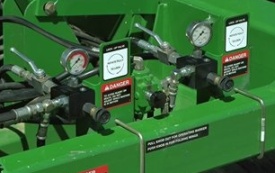 Down pressure adjustment for seed or fertilizer
Down pressure adjustment for seed or fertilizer
Setting the opener down pressure is convenient and easy to adjust.
For 9.1-, 11.0-, 12.2-, and 13.1-m (30-, 36-, 40-, and 43-ft) widths the down pressure on the front fertilizer rockshaft is adjusted independently of the middle and rear seed opener rockshafts. Simply dial in the required pressure using the knobs.
The seed opener pressure gauge face is color coded to provide a guide for normal pressure operating ranges.
 Valve block
Valve block
The valve has two internal checks to reduce possibility of damage to valve when charging the system.
The down pressure cylinder is connected to live hydraulics and extends or retracts to maintain uniform down pressure on openers.
This system is compatible with either closed center or pressure flow compensated tractor hydraulic systems.
IMPORTANT: Tractors with open-center hydraulics require an open-center kit with change valve (order code 6505 to make the air drill compatible). The open-center application does not provide an opener flexibility feature.
Air Power™ 2 fan system and compatibility
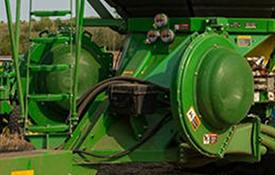 Air Power 2 fan system
Air Power 2 fan system
Enhanced air seeding performance would not be possible without the updates to the 15,152.8-L (430-bu) and 19,381.5-L (550-bu) 1910 and C850 Air Carts. For the wider seeding width, more fan capacity has been added.
Air Power 2 provides two independently controlled fans – one for seed and one for fertilizer. Along with large, 76.2-mm (3-in.) primaries, more accurate delivery rates are possible across the full width of the seeding tool, from opener to opener. Plus, Air Power 2 allows growers to deliver high rates under field operating conditions – up to 40 percent more product delivery per primary compared to the single-fan system.
Dual fans are required for tow-between and tow-behind carts on the 23.2-m (76-ft) P576 and 18.3-m (60-ft) N560F models along with the eight primaries. Each fan will direct air to one set of primaries. Two selective control valves (SCVs) are required for the fans. The fan speed will be controlled through the SCV flow control.
Air Power 2 will also be compatible with the 17.1-m (56-ft) P556 and 23.2-m (76-ft) P576 Air Hoe Drills, as well as the 13.1-m (43-ft) N543F and 18.3-m (60-ft) N560F Disk Drills, plus the 15.2-m (50-ft) and 18.3-m (60-ft) 1890 models. An option is available for stainless-steel primaries to resist corrosion from high fertilizer rates.
 C850 Air Cart
C850 Air Cart
There is a slide at the meter to choose bottom or top shoot for each meter. There is also a valve on the tank pressure system to choose top or bottom shoot. This same valve is used to adjust the amount of air to the tank to create the proper pressure differential.
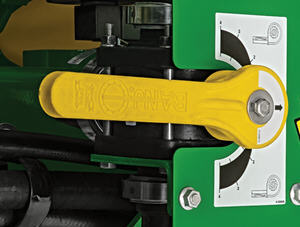 Tank pressure valve
Tank pressure valve
The arrow on the valve handle should be pointing to the top of the range for the top shoot and the bottom of the range for the bottom shoot. If the tank will not be in use, set the pressure valve to the middle setting to not pressurize the tank. The operator should use the gauge to find the correct setting. An electronic pressure sensor will send a warning to the display if the tank pressure differential is out of range.
If pressure is in the green operating range, the tanks are sealed and operating correctly. The electronic pressure sensor is located behind the mechanical gauge on the side of the cart.
RelativeFlow™ Blockage sensing
 RelativeFlow blockage sensing
RelativeFlow blockage sensing
With the RelativeFlow blockage system, operators can see the flow rate of both seed and fertilizer from inside the tractor cab. Sensors on delivery hoses monitor the relative rate of product flow. An easy-to-read display clearly visualizes relative product flow across the drill, from opener to opener. This exclusive technology gives a better view of what is happening across the tool in order to spot problems before blockage occurs.
RelativeFlow Blockage is available on the following models:
- P540 - 12.2-m (40-ft)
- P556 - 17.1-m (56-ft)
- P576 - 23.2-m (76-ft)
- N500C - all widths
- 1890 - 15.2-m (50-ft) and 18.3-m (60-ft)
- N530F - 9.1-m (30-ft)
- N540F - 12.2-m (40-ft)
- N543F - 13.1-m (43-ft)
- N560F - 18.3-m (60-ft)
Below are the GreenStar™ 3 2630 Display screens for the blockage monitoring system. For complete details and information, see the owner’s manual.
 Blockage monitoring screen
Blockage monitoring screen
The RelativeFlow system chart shows the amount of flow through each sensor on the selected tower. Sensitivity for the blockage system can be adjusted if desired, as shown below.
 Blockage set-up screen
Blockage set-up screen
Blockage warning sensitivity allows the producer to set and change the sensitivity of the sensors to meet their preferences. Increasing the sensitivity means the system is more likely to show a false blockage, while less sensitivity means the system is more likely to miss a blockage.
Multiple run-page alarm behavior options are available for selection.
 Blockage set-up screen
Blockage set-up screen
Below are the Gen 4 display screens for the blockage monitoring system on the N500C.
For complete details and information reference, the owner’s manual.
 RelativeFlow Blockage configured run page
RelativeFlow Blockage configured run page
The SeedStar™ system run page displays the five major run settings. Clicking on any of the tiles will take an operator to that specific page (shown below).
 Operators can zoom into flow details by meter section when selecting Blockage tiles
Operators can zoom into flow details by meter section when selecting Blockage tiles
 Operators can zoom into the row level to access row/sensor information and turn a sensor on/off independently
Operators can zoom into the row level to access row/sensor information and turn a sensor on/off independently
 Blockage sensitivities and alarm delays are all set up on one easy-to-navigate screen
Blockage sensitivities and alarm delays are all set up on one easy-to-navigate screen
Blockage alarm delays can be set up by clicking on the advanced settings button from the blockage set-up screen.
- A blockage delay is how long a blockage should occur before an alarm is sounded.
- The blockage alarm reminder is how often the alarm should sound when a blockage occurs.
- The meter on delay is the time from when the meter is turned on until the blockage sensor should start monitoring for blockage.
- The meter off delay is the time from when the meter is turned off until the blockage sensor should start monitoring to verify no flow.
For more detailed information, see the owner’s manual.
Air tools with Relative Flow Blockage are not compatible with 1910 air carts with ground drive.
TruSet™ system downforce control
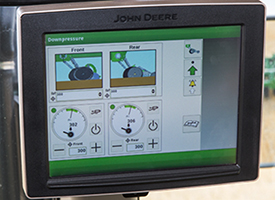 Downforce control from the cab
Downforce control from the cab
TruSet downforce control enables operators to conveniently set values for the seed and fertilizer ranks independently from the cab. This feature enables them to meet optimal downforce pressure while in varying soil conditions. TruSet downforce control improves seed placement accuracy in varying field conditions, leading to improved emergence and plant maturity.
TruSet system quick-reference guide
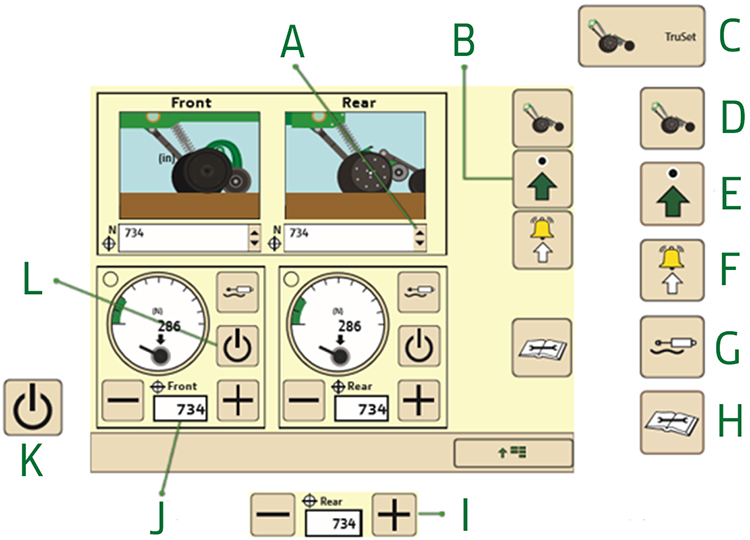
TruSet system quick-reference guide image key:
- Select here to choose from a list of programmed downforce setpoints.
- Select here to enter calibration screens, input downforce setpoints, and to verify the tractor selective control valve (SCV) controlled by automation.
- TruSet – main menu button
- TruSet run screen
- Setup – select to configure tool
- Warning Setup – select to set downforce warnings
- Float Mode – select to toggle the float mode on and off. This option is only available using Power Beyond control options.
- Diagnostics – select to enter diagnostic information
- Press the plus or minus button to increase or decrease the downforce.
- Enter a value here to increase or decrease the downforce.
- Enables the downforce system
- Disables the downforce system
TruSet system tool setup
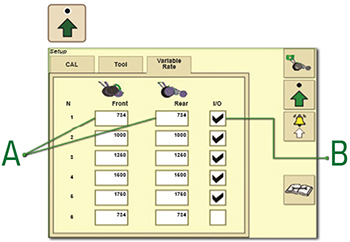 Tool setup
Tool setup
Select the tool setup to enter calibration screens, input downforce setpoints, and to verify the tractor SCV controlled by automation:
- Enter target setpoint for downforce
- Enable pick 6 prescription
TruSet system tool setup - automated SCV
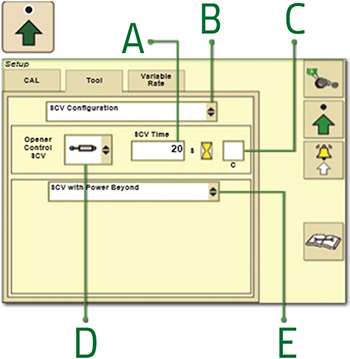
TruSet system tool setup - automated SCV image key:
- This is the time that the SCV remains on to ensure that Power Beyond activates.
- Select SCV configuration
- Enable or disable continuous SCV time
- Select opener control SCV (SCV1-6)
- Select opener control (SCV with Power Beyond, SCV only)
TruSet system tool setup - manual SCV

TruSet system tool setup - manual SCV image key:
- Select opener control SCV Manual (---)
- Select SCV configuration
- Enter values for the extend and retract thresholds if necessary
- Select opener control (SCV with Power Beyond, SCV only)
TruSet system tool setup - Implement Detection
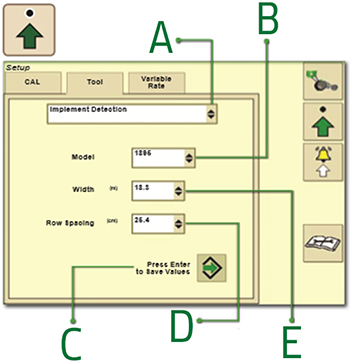
TruSet system tool setup - Implement Detection image key:
- Select Implement Detection
- Select tool mode
- Press to save the values
- Select row spacing
- Select nominal tool width
TruSet system tool setup - opener configuration
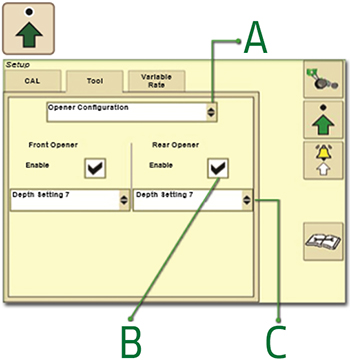
TruSet system tool setup - opener configuration image key:
- Select opener configuration
- Enable and disable opener control
- Select opener depth setting (1 through 13)
Separate fertilizer placement (SFP) offers growing advantages
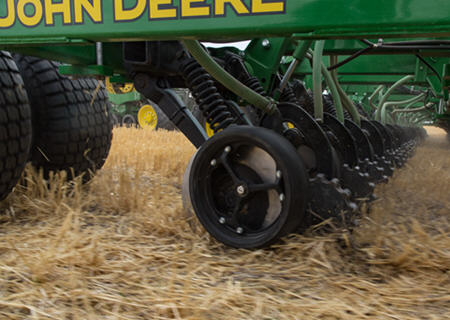 SPF Openers
SPF Openers
Separate fertilizer placement offers nutrient placement at a 5 or 7-degree angle
The 5-degree fertilizer opener:
- Is required for liquid and anhydrous (NH3) fertilizers
- Will also apply dry fertilizer
- Opens a smaller trench than the 7-degree opener
- Is better able to capture anhydrous and liquid fertilizer and seal fertilizers in the soil
Fertilizer tubes
There are four choices of interchangeable fertilizer tubes:
- Dry fertilizer tube to be used with 32-mm (1-1/4-in.) secondary fertilizer hose from the 1910 Cart
- Liquid fertilizer tube (for 13-mm [1/2-in.] i.d. hose)
- IMPORTANT: Using this tube for anhydrous may cause loss of retention
- Dual fertilizer delivery tube – allows for placement of dry or anhydrous. If applying both simultaneously, the operator may need to provide a relief system to relieve air from dry tube for adequate anhydrous retention. Without air relief, the operator will need to adjust air plenum to restrict all airflow to SFP dry tubes when anhydrous is being applied
- Anhydrous tube (for 10-mm [3/8-in.] i.d. hose)
- Liquid or NH3 fertilizer metering/delivery system is not provided by the John Deere Seeding Group
Key features of the SFP opener are:
- 457.2-mm (18-in.) opener blades operate at 5 degrees, resulting in a narrow trench with less soil disturbance
- Fertilizer tubes are interchangeable among dry, liquid, or anhydrous (NH3)
- Closing wheel assembly is closer to the fertilizer delivery tube; provides increased fertilizer retention
- Serrated closing wheels are base equipment on anhydrous openers and optional on liquid and dry openers
- NOTE: Closing wheels are recommended when dry soil conditions are common.
- Extended-wear (chrome alloy) fertilizer boots are standard equipment
- Choice of five different gauge wheels
- Depth adjustments in 6-mm (1/4-in.) increments from 13 mm to 89 mm (1/2 in. to 3.5 in.) deep
Opener furrow-closing wheel
The 25-mm x 305-mm (1-in. x 12-in.) cast closing wheel follows the press wheel to close the furrow, placing soil over seed or fertilizer after the press wheel secures the seed in the furrow.
- A double-row ball bearing to reduce wear is located in the arm of the closing wheel
- Mounted parallel to the furrow opener, the closing wheel can be adjusted laterally to allow running on top of the furrow for sandy or mellow soils or to side of the furrow for heavier soils
- Down pressure is adjustable from 11.8 kg to 19.5 kg (26 lb to 43 lb) (no tools and three adjustments)
- A grease fitting in the pivot arm provides free movement for the arm
ProSeries™ Openers provide excellent penetration
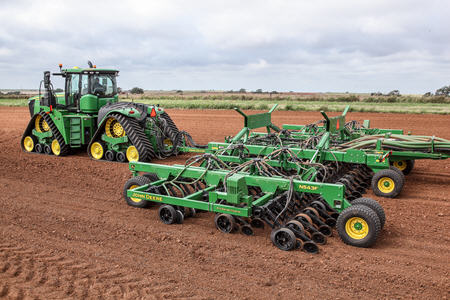 ProSeries Openers
ProSeries Openers
ProSeries Openers are in base equipment on all 1890 and N500F Separate Fertilizer Placement (SFP), 1990 Central Commodity System (CCS™), and 1590 Air Drills.
On the 1890 models, the single-disk openers are on 190-mm (7.5-in.) or 254-mm (10-in.) row spacing. On 15.25-m (50-ft) and 18.3-m (60-ft) 1890 models, the 190-mm/380-mm (7.5-in./15-in.) or 254-mm/508-mm (10-in./20-in.) dual-row spacing feature is in base equipment. The single-disk openers provide consistent and accurate seed placement.
The ProSeries Openers are gang mounted and are hydraulically raised and lowered. The hydraulic downforce system also offers a wide range of downforce settings for the openers.
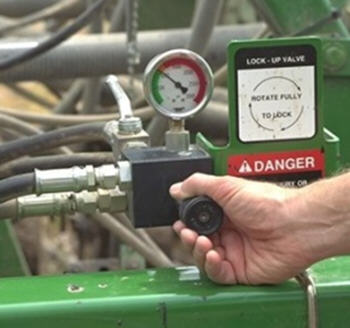 Active hydraulic downforce pressure valve
Active hydraulic downforce pressure valve
The active hydraulics:
- Work in conjunction with the opener spring
- Provide an adjustable range of 75 kg (165 lb) to 180 kg (400 lb) of down pressure per opener
- Benefit: penetrate hard soils and heavy residue
- The cylinders allow the openers to travel up or down an additional 405 mm (16 in.) with active hydraulic down pressure to follow the ground
- Provide the openers additional pressure when needed or allow the openers to go into relief if the pressure becomes too high
The down pressure:
- Is easily adjusted with the pressure valve located on the front of the mainframe
- Provides the operator the ability to quickly adjust, or dial in, the down pressure as operating conditions change
NOTE: For additional ballast in hard-to-penetrate conditions, tractor suitcase weights may also be added to the mainframe and wings to obtain maximum down pressure per opener.
The ProSeries Openers:
- Work not only in no-till conditions, but also in minimum or reduced-till conditions
- Provide 51 mm (2 in.) of free travel in the opener before spring down pressure takes over
- Benefit: allows the opener to move over uneven ground conditions and minimize the chance of the gauge wheels bulldozing soil in soft or mellow conditions
- The opener spring travels a maximum of 203-mm (8-in.) up or 150-mm (6-in.) down before the hydraulics react to uneven seedbeds
Green on Green Integration
Tractor, cart, and display compatibility
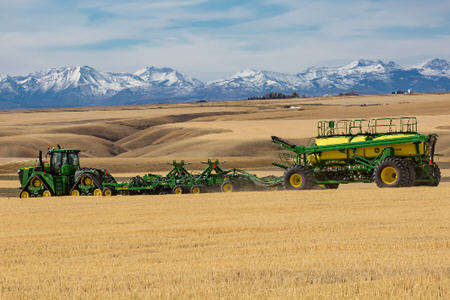
The 18.3-m (60-ft) tool is five sections with 254-mm (10-in.) spacing and is Air Power™ 2 compatible. This larger tool will require a 15,152.8-L (430-bu) tow-between cart, a 15,152.8-L or 19,381.5-L (430-bu or 550 bu) tow-behind cart, or the C850 Air Cart with Air Power 2 dual fan system. Along with this cart compatibility, breaks are required for this configuration due to the weight of the drill and cart versus the tractor during transport mode. Below are compatible tractor, horsepower, display, and engine specific details.
Cart compatibility
- 1910 Carts equipped with Air Power 2
- 15,152.8-L (430 bu) tow-between cart
- 15,152.8-L (430 bu) tow-behind cart
- 19,381.5-L (550 bu) tow-behind cart
- C850 Air Cart
Along with the added tool size, the N500F offers a heavy-duty hitch to pull an additional 20,412 kg (45,000 lb), which is the equivalent of two 7570-L (2,000-gal.) NH3 tanks when using a tow-between cart.
Tractor compatibility
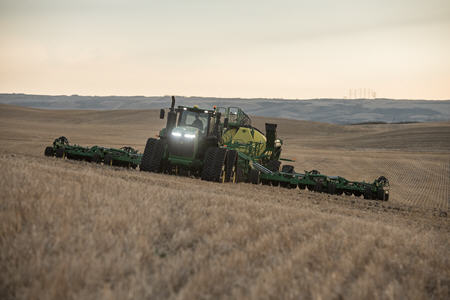 Cart and tractor compatibility
Cart and tractor compatibility
- Recommended minimum 425-kW (570-hp) tractor with a 295.3-L/min (78-gpm) high-flow pump
- Follow recommended ballasting guidelines
- Requires a tractor with four selective control valves (SCVs) plus power beyond
- Requires a brake port for 1910 and C850 Air Cart brakes
- Flat ground - seeding less than 2.5 cm (1 in.)
- 425 kW (570 hp)
- Flat ground - seeding greater than 2.5 cm (1 in.)
- 462.3 kW (620 hp)
- Hilly terrain - seeding at any depth
- 462.3 kW (620 hp with tracks - recommended to obtain proper wheel slip)
- Flat ground - seeding less than 2.5 cm (1 in.)
Engine power capabilities
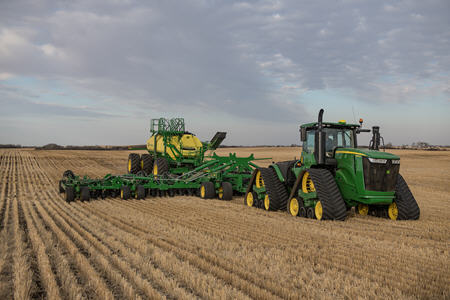 Engine power to pull carts
Engine power to pull carts
- The seeding tool system must be compatible with the maximum power that the largest Final Tier 4 (FT4) or comparable manufacturer’s tractor can produce.
- FT4 tractors have an advertised engine horsepower of up to rated power level of 462.3 kW (620 hp). Power bulge for short periods of time increase this to 499.6 kW (670 hp).
- Pulling a full 15,152.8-L (430-bu) cart requires about 51.5 kW (69 hp), the 19,381.5-L (550-bu) cart requires about 66.4 kW (89 hp), and the 29,953.2-L (850-bu) cart requires about 96.9 kW (130 hp).
Display compatibility
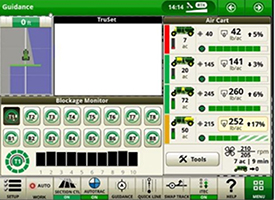 Display compatibility with carts
Display compatibility with carts
This larger tool was designed for the Gen 4 CommandCenter™ display. This technology integration saves time and money.
- 4600 CommandCenter™ display with Premium Activation
- 4640 Universal Display with core activation
ProSeries™ Opener performance upgrade kit
Growers that may be interested in upgrading their current 90 Series Openers to the ProSeries Openers can do this by ordering a ProSeries performance upgrade kit.
Two kit offerings are available for seed openers, a two row (AA98693) and eight row (AA97392) kit. The breakdowns are as follows:
AA98693
| A105410 | Deflector, seed firmer tab | 2 pc |
| A107506 | Washer, special | 8 pc |
| A109343 | Seed boot, left hand | 1 pc |
| A109344 | Seed boot, right hand | 1 pc |
| A110307 | Closing arm spring, left hand | 1 pc |
| A110308 | Closing arm spring, right hand | 1 pc |
| A31869 | Locknut | 2 pc |
| AA88056 | Press wheel assembly | 2 pc |
| E55662 | Nut, 3/8 | 8 pc |
| N280653 | Washer | 2 pc |
| N283804 | Opener disk | 2 pc |
| N283976 | Nut, U-nut | 2 pc |
| N283308 | Screw, flange | 2 pc |
| 03H2070 | Bolt, round head | 8 pc |
| 19M7720 | Screw, hex | 2 pc |
| A105392 | Spiked seed closing wheel | 2 pc |
| A97699 | Instructions, dealer download | 1 pc |
AA97392
| A105410 | Deflector, seed firmer tab | 8 pc |
| A107506 | Washer, special | 32 pc |
| A109343 | Seed boot, left hand | 4 pc |
| A109344 | Seed boot, right hand | 4 pc |
| A110307 | Closing arm spring, left hand | 4 pc |
| A110308 | Closing arm spring, right hand | 4 pc |
| A31869 | Locknut | 8 pc |
| AA88056 | Press wheel assembly | 8 pc |
| E55662 | Nut, 3/8 | 32 pc |
| N280653 | Washer | 8 pc |
| N283804 | Opener disk | 8 pc |
| N283976 | Nut, U-nut | 8 pc |
| N283308 | Screw, flange | 8 pc |
| 03H2070 | Bolt, round head | 32 pc |
| 19M7720 | Screw, hex | 8 pc |
| A105392 | Spiked seed closing wheel | 8 pc |
| A117632 | Instructions, ProSeries | 1 pc |
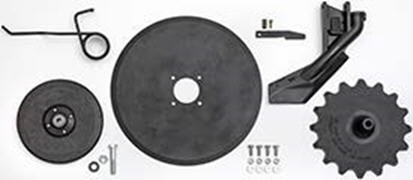 ProSeries seed opener kit
ProSeries seed opener kit
NOTE: Kits are subject to change.
Features
Independent seed and fertilizer down pressure adjustment
 Down pressure adjustment for seed or fertilizer
Down pressure adjustment for seed or fertilizer
Setting the opener down pressure is convenient and easy to adjust.
For 9.1-, 11.0-, 12.2-, and 13.1-m (30-, 36-, 40-, and 43-ft) widths the down pressure on the front fertilizer rockshaft is adjusted independently of the middle and rear seed opener rockshafts. Simply dial in the required pressure using the knobs.
The seed opener pressure gauge face is color coded to provide a guide for normal pressure operating ranges.
 Valve block
Valve block
The valve has two internal checks to reduce possibility of damage to valve when charging the system.
The down pressure cylinder is connected to live hydraulics and extends or retracts to maintain uniform down pressure on openers.
This system is compatible with either closed center or pressure flow compensated tractor hydraulic systems.
IMPORTANT: Tractors with open-center hydraulics require an open-center kit with change valve (order code 6505 to make the air drill compatible). The open-center application does not provide an opener flexibility feature.
Air Power™ 2 fan system and compatibility
 Air Power 2 fan system
Air Power 2 fan system
Enhanced air seeding performance would not be possible without the updates to the 15,152.8-L (430-bu) and 19,381.5-L (550-bu) 1910 and C850 Air Carts. For the wider seeding width, more fan capacity has been added.
Air Power 2 provides two independently controlled fans – one for seed and one for fertilizer. Along with large, 76.2-mm (3-in.) primaries, more accurate delivery rates are possible across the full width of the seeding tool, from opener to opener. Plus, Air Power 2 allows growers to deliver high rates under field operating conditions – up to 40 percent more product delivery per primary compared to the single-fan system.
Dual fans are required for tow-between and tow-behind carts on the 23.2-m (76-ft) P576 and 18.3-m (60-ft) N560F models along with the eight primaries. Each fan will direct air to one set of primaries. Two selective control valves (SCVs) are required for the fans. The fan speed will be controlled through the SCV flow control.
Air Power 2 will also be compatible with the 17.1-m (56-ft) P556 and 23.2-m (76-ft) P576 Air Hoe Drills, as well as the 13.1-m (43-ft) N543F and 18.3-m (60-ft) N560F Disk Drills, plus the 15.2-m (50-ft) and 18.3-m (60-ft) 1890 models. An option is available for stainless-steel primaries to resist corrosion from high fertilizer rates.
 C850 Air Cart
C850 Air Cart
There is a slide at the meter to choose bottom or top shoot for each meter. There is also a valve on the tank pressure system to choose top or bottom shoot. This same valve is used to adjust the amount of air to the tank to create the proper pressure differential.
 Tank pressure valve
Tank pressure valve
The arrow on the valve handle should be pointing to the top of the range for the top shoot and the bottom of the range for the bottom shoot. If the tank will not be in use, set the pressure valve to the middle setting to not pressurize the tank. The operator should use the gauge to find the correct setting. An electronic pressure sensor will send a warning to the display if the tank pressure differential is out of range.
If pressure is in the green operating range, the tanks are sealed and operating correctly. The electronic pressure sensor is located behind the mechanical gauge on the side of the cart.
RelativeFlow™ Blockage sensing
 RelativeFlow blockage sensing
RelativeFlow blockage sensing
With the RelativeFlow blockage system, operators can see the flow rate of both seed and fertilizer from inside the tractor cab. Sensors on delivery hoses monitor the relative rate of product flow. An easy-to-read display clearly visualizes relative product flow across the drill, from opener to opener. This exclusive technology gives a better view of what is happening across the tool in order to spot problems before blockage occurs.
RelativeFlow Blockage is available on the following models:
- P540 - 12.2-m (40-ft)
- P556 - 17.1-m (56-ft)
- P576 - 23.2-m (76-ft)
- N500C - all widths
- 1890 - 15.2-m (50-ft) and 18.3-m (60-ft)
- N530F - 9.1-m (30-ft)
- N540F - 12.2-m (40-ft)
- N543F - 13.1-m (43-ft)
- N560F - 18.3-m (60-ft)
Below are the GreenStar™ 3 2630 Display screens for the blockage monitoring system. For complete details and information, see the owner’s manual.
 Blockage monitoring screen
Blockage monitoring screen
The RelativeFlow system chart shows the amount of flow through each sensor on the selected tower. Sensitivity for the blockage system can be adjusted if desired, as shown below.
 Blockage set-up screen
Blockage set-up screen
Blockage warning sensitivity allows the producer to set and change the sensitivity of the sensors to meet their preferences. Increasing the sensitivity means the system is more likely to show a false blockage, while less sensitivity means the system is more likely to miss a blockage.
Multiple run-page alarm behavior options are available for selection.
 Blockage set-up screen
Blockage set-up screen
Below are the Gen 4 display screens for the blockage monitoring system on the N500C.
For complete details and information reference, the owner’s manual.
 RelativeFlow Blockage configured run page
RelativeFlow Blockage configured run page
The SeedStar™ system run page displays the five major run settings. Clicking on any of the tiles will take an operator to that specific page (shown below).
 Operators can zoom into flow details by meter section when selecting Blockage tiles
Operators can zoom into flow details by meter section when selecting Blockage tiles
 Operators can zoom into the row level to access row/sensor information and turn a sensor on/off independently
Operators can zoom into the row level to access row/sensor information and turn a sensor on/off independently
 Blockage sensitivities and alarm delays are all set up on one easy-to-navigate screen
Blockage sensitivities and alarm delays are all set up on one easy-to-navigate screen
Blockage alarm delays can be set up by clicking on the advanced settings button from the blockage set-up screen.
- A blockage delay is how long a blockage should occur before an alarm is sounded.
- The blockage alarm reminder is how often the alarm should sound when a blockage occurs.
- The meter on delay is the time from when the meter is turned on until the blockage sensor should start monitoring for blockage.
- The meter off delay is the time from when the meter is turned off until the blockage sensor should start monitoring to verify no flow.
For more detailed information, see the owner’s manual.
Air tools with Relative Flow Blockage are not compatible with 1910 air carts with ground drive.
TruSet™ system downforce control
 Downforce control from the cab
Downforce control from the cab
TruSet downforce control enables operators to conveniently set values for the seed and fertilizer ranks independently from the cab. This feature enables them to meet optimal downforce pressure while in varying soil conditions. TruSet downforce control improves seed placement accuracy in varying field conditions, leading to improved emergence and plant maturity.
TruSet system quick-reference guide

TruSet system quick-reference guide image key:
- Select here to choose from a list of programmed downforce setpoints.
- Select here to enter calibration screens, input downforce setpoints, and to verify the tractor selective control valve (SCV) controlled by automation.
- TruSet – main menu button
- TruSet run screen
- Setup – select to configure tool
- Warning Setup – select to set downforce warnings
- Float Mode – select to toggle the float mode on and off. This option is only available using Power Beyond control options.
- Diagnostics – select to enter diagnostic information
- Press the plus or minus button to increase or decrease the downforce.
- Enter a value here to increase or decrease the downforce.
- Enables the downforce system
- Disables the downforce system
TruSet system tool setup
 Tool setup
Tool setup
Select the tool setup to enter calibration screens, input downforce setpoints, and to verify the tractor SCV controlled by automation:
- Enter target setpoint for downforce
- Enable pick 6 prescription
TruSet system tool setup - automated SCV

TruSet system tool setup - automated SCV image key:
- This is the time that the SCV remains on to ensure that Power Beyond activates.
- Select SCV configuration
- Enable or disable continuous SCV time
- Select opener control SCV (SCV1-6)
- Select opener control (SCV with Power Beyond, SCV only)
TruSet system tool setup - manual SCV

TruSet system tool setup - manual SCV image key:
- Select opener control SCV Manual (---)
- Select SCV configuration
- Enter values for the extend and retract thresholds if necessary
- Select opener control (SCV with Power Beyond, SCV only)
TruSet system tool setup - Implement Detection

TruSet system tool setup - Implement Detection image key:
- Select Implement Detection
- Select tool mode
- Press to save the values
- Select row spacing
- Select nominal tool width
TruSet system tool setup - opener configuration

TruSet system tool setup - opener configuration image key:
- Select opener configuration
- Enable and disable opener control
- Select opener depth setting (1 through 13)
Separate fertilizer placement (SFP) offers growing advantages
 SPF Openers
SPF Openers
Separate fertilizer placement offers nutrient placement at a 5 or 7-degree angle
The 5-degree fertilizer opener:
- Is required for liquid and anhydrous (NH3) fertilizers
- Will also apply dry fertilizer
- Opens a smaller trench than the 7-degree opener
- Is better able to capture anhydrous and liquid fertilizer and seal fertilizers in the soil
Fertilizer tubes
There are four choices of interchangeable fertilizer tubes:
- Dry fertilizer tube to be used with 32-mm (1-1/4-in.) secondary fertilizer hose from the 1910 Cart
- Liquid fertilizer tube (for 13-mm [1/2-in.] i.d. hose)
- IMPORTANT: Using this tube for anhydrous may cause loss of retention
- Dual fertilizer delivery tube – allows for placement of dry or anhydrous. If applying both simultaneously, the operator may need to provide a relief system to relieve air from dry tube for adequate anhydrous retention. Without air relief, the operator will need to adjust air plenum to restrict all airflow to SFP dry tubes when anhydrous is being applied
- Anhydrous tube (for 10-mm [3/8-in.] i.d. hose)
- Liquid or NH3 fertilizer metering/delivery system is not provided by the John Deere Seeding Group
Key features of the SFP opener are:
- 457.2-mm (18-in.) opener blades operate at 5 degrees, resulting in a narrow trench with less soil disturbance
- Fertilizer tubes are interchangeable among dry, liquid, or anhydrous (NH3)
- Closing wheel assembly is closer to the fertilizer delivery tube; provides increased fertilizer retention
- Serrated closing wheels are base equipment on anhydrous openers and optional on liquid and dry openers
- NOTE: Closing wheels are recommended when dry soil conditions are common.
- Extended-wear (chrome alloy) fertilizer boots are standard equipment
- Choice of five different gauge wheels
- Depth adjustments in 6-mm (1/4-in.) increments from 13 mm to 89 mm (1/2 in. to 3.5 in.) deep
Opener furrow-closing wheel
The 25-mm x 305-mm (1-in. x 12-in.) cast closing wheel follows the press wheel to close the furrow, placing soil over seed or fertilizer after the press wheel secures the seed in the furrow.
- A double-row ball bearing to reduce wear is located in the arm of the closing wheel
- Mounted parallel to the furrow opener, the closing wheel can be adjusted laterally to allow running on top of the furrow for sandy or mellow soils or to side of the furrow for heavier soils
- Down pressure is adjustable from 11.8 kg to 19.5 kg (26 lb to 43 lb) (no tools and three adjustments)
- A grease fitting in the pivot arm provides free movement for the arm
ProSeries™ Openers provide excellent penetration
 ProSeries Openers
ProSeries Openers
ProSeries Openers are in base equipment on all 1890 and N500F Separate Fertilizer Placement (SFP), 1990 Central Commodity System (CCS™), and 1590 Air Drills.
On the 1890 models, the single-disk openers are on 190-mm (7.5-in.) or 254-mm (10-in.) row spacing. On 15.25-m (50-ft) and 18.3-m (60-ft) 1890 models, the 190-mm/380-mm (7.5-in./15-in.) or 254-mm/508-mm (10-in./20-in.) dual-row spacing feature is in base equipment. The single-disk openers provide consistent and accurate seed placement.
The ProSeries Openers are gang mounted and are hydraulically raised and lowered. The hydraulic downforce system also offers a wide range of downforce settings for the openers.
 Active hydraulic downforce pressure valve
Active hydraulic downforce pressure valve
The active hydraulics:
- Work in conjunction with the opener spring
- Provide an adjustable range of 75 kg (165 lb) to 180 kg (400 lb) of down pressure per opener
- Benefit: penetrate hard soils and heavy residue
- The cylinders allow the openers to travel up or down an additional 405 mm (16 in.) with active hydraulic down pressure to follow the ground
- Provide the openers additional pressure when needed or allow the openers to go into relief if the pressure becomes too high
The down pressure:
- Is easily adjusted with the pressure valve located on the front of the mainframe
- Provides the operator the ability to quickly adjust, or dial in, the down pressure as operating conditions change
NOTE: For additional ballast in hard-to-penetrate conditions, tractor suitcase weights may also be added to the mainframe and wings to obtain maximum down pressure per opener.
The ProSeries Openers:
- Work not only in no-till conditions, but also in minimum or reduced-till conditions
- Provide 51 mm (2 in.) of free travel in the opener before spring down pressure takes over
- Benefit: allows the opener to move over uneven ground conditions and minimize the chance of the gauge wheels bulldozing soil in soft or mellow conditions
- The opener spring travels a maximum of 203-mm (8-in.) up or 150-mm (6-in.) down before the hydraulics react to uneven seedbeds
Green on Green Integration
Tractor, cart, and display compatibility

The 18.3-m (60-ft) tool is five sections with 254-mm (10-in.) spacing and is Air Power™ 2 compatible. This larger tool will require a 15,152.8-L (430-bu) tow-between cart, a 15,152.8-L or 19,381.5-L (430-bu or 550 bu) tow-behind cart, or the C850 Air Cart with Air Power 2 dual fan system. Along with this cart compatibility, breaks are required for this configuration due to the weight of the drill and cart versus the tractor during transport mode. Below are compatible tractor, horsepower, display, and engine specific details.
Cart compatibility
- 1910 Carts equipped with Air Power 2
- 15,152.8-L (430 bu) tow-between cart
- 15,152.8-L (430 bu) tow-behind cart
- 19,381.5-L (550 bu) tow-behind cart
- C850 Air Cart
Along with the added tool size, the N500F offers a heavy-duty hitch to pull an additional 20,412 kg (45,000 lb), which is the equivalent of two 7570-L (2,000-gal.) NH3 tanks when using a tow-between cart.
Tractor compatibility
 Cart and tractor compatibility
Cart and tractor compatibility
- Recommended minimum 425-kW (570-hp) tractor with a 295.3-L/min (78-gpm) high-flow pump
- Follow recommended ballasting guidelines
- Requires a tractor with four selective control valves (SCVs) plus power beyond
- Requires a brake port for 1910 and C850 Air Cart brakes
- Flat ground - seeding less than 2.5 cm (1 in.)
- 425 kW (570 hp)
- Flat ground - seeding greater than 2.5 cm (1 in.)
- 462.3 kW (620 hp)
- Hilly terrain - seeding at any depth
- 462.3 kW (620 hp with tracks - recommended to obtain proper wheel slip)
- Flat ground - seeding less than 2.5 cm (1 in.)
Engine power capabilities
 Engine power to pull carts
Engine power to pull carts
- The seeding tool system must be compatible with the maximum power that the largest Final Tier 4 (FT4) or comparable manufacturer’s tractor can produce.
- FT4 tractors have an advertised engine horsepower of up to rated power level of 462.3 kW (620 hp). Power bulge for short periods of time increase this to 499.6 kW (670 hp).
- Pulling a full 15,152.8-L (430-bu) cart requires about 51.5 kW (69 hp), the 19,381.5-L (550-bu) cart requires about 66.4 kW (89 hp), and the 29,953.2-L (850-bu) cart requires about 96.9 kW (130 hp).
Display compatibility
 Display compatibility with carts
Display compatibility with carts
This larger tool was designed for the Gen 4 CommandCenter™ display. This technology integration saves time and money.
- 4600 CommandCenter™ display with Premium Activation
- 4640 Universal Display with core activation
ProSeries™ Opener performance upgrade kit
Growers that may be interested in upgrading their current 90 Series Openers to the ProSeries Openers can do this by ordering a ProSeries performance upgrade kit.
Two kit offerings are available for seed openers, a two row (AA98693) and eight row (AA97392) kit. The breakdowns are as follows:
AA98693
| A105410 | Deflector, seed firmer tab | 2 pc |
| A107506 | Washer, special | 8 pc |
| A109343 | Seed boot, left hand | 1 pc |
| A109344 | Seed boot, right hand | 1 pc |
| A110307 | Closing arm spring, left hand | 1 pc |
| A110308 | Closing arm spring, right hand | 1 pc |
| A31869 | Locknut | 2 pc |
| AA88056 | Press wheel assembly | 2 pc |
| E55662 | Nut, 3/8 | 8 pc |
| N280653 | Washer | 2 pc |
| N283804 | Opener disk | 2 pc |
| N283976 | Nut, U-nut | 2 pc |
| N283308 | Screw, flange | 2 pc |
| 03H2070 | Bolt, round head | 8 pc |
| 19M7720 | Screw, hex | 2 pc |
| A105392 | Spiked seed closing wheel | 2 pc |
| A97699 | Instructions, dealer download | 1 pc |
AA97392
| A105410 | Deflector, seed firmer tab | 8 pc |
| A107506 | Washer, special | 32 pc |
| A109343 | Seed boot, left hand | 4 pc |
| A109344 | Seed boot, right hand | 4 pc |
| A110307 | Closing arm spring, left hand | 4 pc |
| A110308 | Closing arm spring, right hand | 4 pc |
| A31869 | Locknut | 8 pc |
| AA88056 | Press wheel assembly | 8 pc |
| E55662 | Nut, 3/8 | 32 pc |
| N280653 | Washer | 8 pc |
| N283804 | Opener disk | 8 pc |
| N283976 | Nut, U-nut | 8 pc |
| N283308 | Screw, flange | 8 pc |
| 03H2070 | Bolt, round head | 32 pc |
| 19M7720 | Screw, hex | 8 pc |
| A105392 | Spiked seed closing wheel | 8 pc |
| A117632 | Instructions, ProSeries | 1 pc |
 ProSeries seed opener kit
ProSeries seed opener kit
NOTE: Kits are subject to change.
Features
Independent seed and fertilizer down pressure adjustment
 Down pressure adjustment for seed or fertilizer
Down pressure adjustment for seed or fertilizer
Setting the opener down pressure is convenient and easy to adjust.
For 9.1-, 11.0-, 12.2-, and 13.1-m (30-, 36-, 40-, and 43-ft) widths the down pressure on the front fertilizer rockshaft is adjusted independently of the middle and rear seed opener rockshafts. Simply dial in the required pressure using the knobs.
The seed opener pressure gauge face is color coded to provide a guide for normal pressure operating ranges.
 Valve block
Valve block
The valve has two internal checks to reduce possibility of damage to valve when charging the system.
The down pressure cylinder is connected to live hydraulics and extends or retracts to maintain uniform down pressure on openers.
This system is compatible with either closed center or pressure flow compensated tractor hydraulic systems.
IMPORTANT: Tractors with open-center hydraulics require an open-center kit with change valve (order code 6505 to make the air drill compatible). The open-center application does not provide an opener flexibility feature.
Air Power™ 2 fan system and compatibility
 Air Power 2 fan system
Air Power 2 fan system
Enhanced air seeding performance would not be possible without the updates to the 15,152.8-L (430-bu) and 19,381.5-L (550-bu) 1910 and C850 Air Carts. For the wider seeding width, more fan capacity has been added.
Air Power 2 provides two independently controlled fans – one for seed and one for fertilizer. Along with large, 76.2-mm (3-in.) primaries, more accurate delivery rates are possible across the full width of the seeding tool, from opener to opener. Plus, Air Power 2 allows growers to deliver high rates under field operating conditions – up to 40 percent more product delivery per primary compared to the single-fan system.
Dual fans are required for tow-between and tow-behind carts on the 23.2-m (76-ft) P576 and 18.3-m (60-ft) N560F models along with the eight primaries. Each fan will direct air to one set of primaries. Two selective control valves (SCVs) are required for the fans. The fan speed will be controlled through the SCV flow control.
Air Power 2 will also be compatible with the 17.1-m (56-ft) P556 and 23.2-m (76-ft) P576 Air Hoe Drills, as well as the 13.1-m (43-ft) N543F and 18.3-m (60-ft) N560F Disk Drills, plus the 15.2-m (50-ft) and 18.3-m (60-ft) 1890 models. An option is available for stainless-steel primaries to resist corrosion from high fertilizer rates.
 C850 Air Cart
C850 Air Cart
There is a slide at the meter to choose bottom or top shoot for each meter. There is also a valve on the tank pressure system to choose top or bottom shoot. This same valve is used to adjust the amount of air to the tank to create the proper pressure differential.
 Tank pressure valve
Tank pressure valve
The arrow on the valve handle should be pointing to the top of the range for the top shoot and the bottom of the range for the bottom shoot. If the tank will not be in use, set the pressure valve to the middle setting to not pressurize the tank. The operator should use the gauge to find the correct setting. An electronic pressure sensor will send a warning to the display if the tank pressure differential is out of range.
If pressure is in the green operating range, the tanks are sealed and operating correctly. The electronic pressure sensor is located behind the mechanical gauge on the side of the cart.
RelativeFlow™ Blockage sensing
 RelativeFlow blockage sensing
RelativeFlow blockage sensing
With the RelativeFlow blockage system, operators can see the flow rate of both seed and fertilizer from inside the tractor cab. Sensors on delivery hoses monitor the relative rate of product flow. An easy-to-read display clearly visualizes relative product flow across the drill, from opener to opener. This exclusive technology gives a better view of what is happening across the tool in order to spot problems before blockage occurs.
RelativeFlow Blockage is available on the following models:
- P540 - 12.2-m (40-ft)
- P556 - 17.1-m (56-ft)
- P576 - 23.2-m (76-ft)
- N500C - all widths
- 1890 - 15.2-m (50-ft) and 18.3-m (60-ft)
- N530F - 9.1-m (30-ft)
- N540F - 12.2-m (40-ft)
- N543F - 13.1-m (43-ft)
- N560F - 18.3-m (60-ft)
Below are the GreenStar™ 3 2630 Display screens for the blockage monitoring system. For complete details and information, see the owner’s manual.
 Blockage monitoring screen
Blockage monitoring screen
The RelativeFlow system chart shows the amount of flow through each sensor on the selected tower. Sensitivity for the blockage system can be adjusted if desired, as shown below.
 Blockage set-up screen
Blockage set-up screen
Blockage warning sensitivity allows the producer to set and change the sensitivity of the sensors to meet their preferences. Increasing the sensitivity means the system is more likely to show a false blockage, while less sensitivity means the system is more likely to miss a blockage.
Multiple run-page alarm behavior options are available for selection.
 Blockage set-up screen
Blockage set-up screen
Below are the Gen 4 display screens for the blockage monitoring system on the N500C.
For complete details and information reference, the owner’s manual.
 RelativeFlow Blockage configured run page
RelativeFlow Blockage configured run page
The SeedStar™ system run page displays the five major run settings. Clicking on any of the tiles will take an operator to that specific page (shown below).
 Operators can zoom into flow details by meter section when selecting Blockage tiles
Operators can zoom into flow details by meter section when selecting Blockage tiles
 Operators can zoom into the row level to access row/sensor information and turn a sensor on/off independently
Operators can zoom into the row level to access row/sensor information and turn a sensor on/off independently
 Blockage sensitivities and alarm delays are all set up on one easy-to-navigate screen
Blockage sensitivities and alarm delays are all set up on one easy-to-navigate screen
Blockage alarm delays can be set up by clicking on the advanced settings button from the blockage set-up screen.
- A blockage delay is how long a blockage should occur before an alarm is sounded.
- The blockage alarm reminder is how often the alarm should sound when a blockage occurs.
- The meter on delay is the time from when the meter is turned on until the blockage sensor should start monitoring for blockage.
- The meter off delay is the time from when the meter is turned off until the blockage sensor should start monitoring to verify no flow.
For more detailed information, see the owner’s manual.
Air tools with Relative Flow Blockage are not compatible with 1910 air carts with ground drive.
TruSet™ system downforce control
 Downforce control from the cab
Downforce control from the cab
TruSet downforce control enables operators to conveniently set values for the seed and fertilizer ranks independently from the cab. This feature enables them to meet optimal downforce pressure while in varying soil conditions. TruSet downforce control improves seed placement accuracy in varying field conditions, leading to improved emergence and plant maturity.
TruSet system quick-reference guide

TruSet system quick-reference guide image key:
- Select here to choose from a list of programmed downforce setpoints.
- Select here to enter calibration screens, input downforce setpoints, and to verify the tractor selective control valve (SCV) controlled by automation.
- TruSet – main menu button
- TruSet run screen
- Setup – select to configure tool
- Warning Setup – select to set downforce warnings
- Float Mode – select to toggle the float mode on and off. This option is only available using Power Beyond control options.
- Diagnostics – select to enter diagnostic information
- Press the plus or minus button to increase or decrease the downforce.
- Enter a value here to increase or decrease the downforce.
- Enables the downforce system
- Disables the downforce system
TruSet system tool setup
 Tool setup
Tool setup
Select the tool setup to enter calibration screens, input downforce setpoints, and to verify the tractor SCV controlled by automation:
- Enter target setpoint for downforce
- Enable pick 6 prescription
TruSet system tool setup - automated SCV

TruSet system tool setup - automated SCV image key:
- This is the time that the SCV remains on to ensure that Power Beyond activates.
- Select SCV configuration
- Enable or disable continuous SCV time
- Select opener control SCV (SCV1-6)
- Select opener control (SCV with Power Beyond, SCV only)
TruSet system tool setup - manual SCV

TruSet system tool setup - manual SCV image key:
- Select opener control SCV Manual (---)
- Select SCV configuration
- Enter values for the extend and retract thresholds if necessary
- Select opener control (SCV with Power Beyond, SCV only)
TruSet system tool setup - Implement Detection

TruSet system tool setup - Implement Detection image key:
- Select Implement Detection
- Select tool mode
- Press to save the values
- Select row spacing
- Select nominal tool width
TruSet system tool setup - opener configuration

TruSet system tool setup - opener configuration image key:
- Select opener configuration
- Enable and disable opener control
- Select opener depth setting (1 through 13)
Separate fertilizer placement (SFP) offers growing advantages
 SPF Openers
SPF Openers
Separate fertilizer placement offers nutrient placement at a 5 or 7-degree angle
The 5-degree fertilizer opener:
- Is required for liquid and anhydrous (NH3) fertilizers
- Will also apply dry fertilizer
- Opens a smaller trench than the 7-degree opener
- Is better able to capture anhydrous and liquid fertilizer and seal fertilizers in the soil
Fertilizer tubes
There are four choices of interchangeable fertilizer tubes:
- Dry fertilizer tube to be used with 32-mm (1-1/4-in.) secondary fertilizer hose from the 1910 Cart
- Liquid fertilizer tube (for 13-mm [1/2-in.] i.d. hose)
- IMPORTANT: Using this tube for anhydrous may cause loss of retention
- Dual fertilizer delivery tube – allows for placement of dry or anhydrous. If applying both simultaneously, the operator may need to provide a relief system to relieve air from dry tube for adequate anhydrous retention. Without air relief, the operator will need to adjust air plenum to restrict all airflow to SFP dry tubes when anhydrous is being applied
- Anhydrous tube (for 10-mm [3/8-in.] i.d. hose)
- Liquid or NH3 fertilizer metering/delivery system is not provided by the John Deere Seeding Group
Key features of the SFP opener are:
- 457.2-mm (18-in.) opener blades operate at 5 degrees, resulting in a narrow trench with less soil disturbance
- Fertilizer tubes are interchangeable among dry, liquid, or anhydrous (NH3)
- Closing wheel assembly is closer to the fertilizer delivery tube; provides increased fertilizer retention
- Serrated closing wheels are base equipment on anhydrous openers and optional on liquid and dry openers
- NOTE: Closing wheels are recommended when dry soil conditions are common.
- Extended-wear (chrome alloy) fertilizer boots are standard equipment
- Choice of five different gauge wheels
- Depth adjustments in 6-mm (1/4-in.) increments from 13 mm to 89 mm (1/2 in. to 3.5 in.) deep
Opener furrow-closing wheel
The 25-mm x 305-mm (1-in. x 12-in.) cast closing wheel follows the press wheel to close the furrow, placing soil over seed or fertilizer after the press wheel secures the seed in the furrow.
- A double-row ball bearing to reduce wear is located in the arm of the closing wheel
- Mounted parallel to the furrow opener, the closing wheel can be adjusted laterally to allow running on top of the furrow for sandy or mellow soils or to side of the furrow for heavier soils
- Down pressure is adjustable from 11.8 kg to 19.5 kg (26 lb to 43 lb) (no tools and three adjustments)
- A grease fitting in the pivot arm provides free movement for the arm
ProSeries™ Openers provide excellent penetration
 ProSeries Openers
ProSeries Openers
ProSeries Openers are in base equipment on all 1890 and N500F Separate Fertilizer Placement (SFP), 1990 Central Commodity System (CCS™), and 1590 Air Drills.
On the 1890 models, the single-disk openers are on 190-mm (7.5-in.) or 254-mm (10-in.) row spacing. On 15.25-m (50-ft) and 18.3-m (60-ft) 1890 models, the 190-mm/380-mm (7.5-in./15-in.) or 254-mm/508-mm (10-in./20-in.) dual-row spacing feature is in base equipment. The single-disk openers provide consistent and accurate seed placement.
The ProSeries Openers are gang mounted and are hydraulically raised and lowered. The hydraulic downforce system also offers a wide range of downforce settings for the openers.
 Active hydraulic downforce pressure valve
Active hydraulic downforce pressure valve
The active hydraulics:
- Work in conjunction with the opener spring
- Provide an adjustable range of 75 kg (165 lb) to 180 kg (400 lb) of down pressure per opener
- Benefit: penetrate hard soils and heavy residue
- The cylinders allow the openers to travel up or down an additional 405 mm (16 in.) with active hydraulic down pressure to follow the ground
- Provide the openers additional pressure when needed or allow the openers to go into relief if the pressure becomes too high
The down pressure:
- Is easily adjusted with the pressure valve located on the front of the mainframe
- Provides the operator the ability to quickly adjust, or dial in, the down pressure as operating conditions change
NOTE: For additional ballast in hard-to-penetrate conditions, tractor suitcase weights may also be added to the mainframe and wings to obtain maximum down pressure per opener.
The ProSeries Openers:
- Work not only in no-till conditions, but also in minimum or reduced-till conditions
- Provide 51 mm (2 in.) of free travel in the opener before spring down pressure takes over
- Benefit: allows the opener to move over uneven ground conditions and minimize the chance of the gauge wheels bulldozing soil in soft or mellow conditions
- The opener spring travels a maximum of 203-mm (8-in.) up or 150-mm (6-in.) down before the hydraulics react to uneven seedbeds
Green on Green Integration
Tractor, cart, and display compatibility

The 18.3-m (60-ft) tool is five sections with 254-mm (10-in.) spacing and is Air Power™ 2 compatible. This larger tool will require a 15,152.8-L (430-bu) tow-between cart, a 15,152.8-L or 19,381.5-L (430-bu or 550 bu) tow-behind cart, or the C850 Air Cart with Air Power 2 dual fan system. Along with this cart compatibility, breaks are required for this configuration due to the weight of the drill and cart versus the tractor during transport mode. Below are compatible tractor, horsepower, display, and engine specific details.
Cart compatibility
- 1910 Carts equipped with Air Power 2
- 15,152.8-L (430 bu) tow-between cart
- 15,152.8-L (430 bu) tow-behind cart
- 19,381.5-L (550 bu) tow-behind cart
- C850 Air Cart
Along with the added tool size, the N500F offers a heavy-duty hitch to pull an additional 20,412 kg (45,000 lb), which is the equivalent of two 7570-L (2,000-gal.) NH3 tanks when using a tow-between cart.
Tractor compatibility
 Cart and tractor compatibility
Cart and tractor compatibility
- Recommended minimum 425-kW (570-hp) tractor with a 295.3-L/min (78-gpm) high-flow pump
- Follow recommended ballasting guidelines
- Requires a tractor with four selective control valves (SCVs) plus power beyond
- Requires a brake port for 1910 and C850 Air Cart brakes
- Flat ground - seeding less than 2.5 cm (1 in.)
- 425 kW (570 hp)
- Flat ground - seeding greater than 2.5 cm (1 in.)
- 462.3 kW (620 hp)
- Hilly terrain - seeding at any depth
- 462.3 kW (620 hp with tracks - recommended to obtain proper wheel slip)
- Flat ground - seeding less than 2.5 cm (1 in.)
Engine power capabilities
 Engine power to pull carts
Engine power to pull carts
- The seeding tool system must be compatible with the maximum power that the largest Final Tier 4 (FT4) or comparable manufacturer’s tractor can produce.
- FT4 tractors have an advertised engine horsepower of up to rated power level of 462.3 kW (620 hp). Power bulge for short periods of time increase this to 499.6 kW (670 hp).
- Pulling a full 15,152.8-L (430-bu) cart requires about 51.5 kW (69 hp), the 19,381.5-L (550-bu) cart requires about 66.4 kW (89 hp), and the 29,953.2-L (850-bu) cart requires about 96.9 kW (130 hp).
Display compatibility
 Display compatibility with carts
Display compatibility with carts
This larger tool was designed for the Gen 4 CommandCenter™ display. This technology integration saves time and money.
- 4600 CommandCenter™ display with Premium Activation
- 4640 Universal Display with core activation
ProSeries™ Opener performance upgrade kit
Growers that may be interested in upgrading their current 90 Series Openers to the ProSeries Openers can do this by ordering a ProSeries performance upgrade kit.
Two kit offerings are available for seed openers, a two row (AA98693) and eight row (AA97392) kit. The breakdowns are as follows:
AA98693
| A105410 | Deflector, seed firmer tab | 2 pc |
| A107506 | Washer, special | 8 pc |
| A109343 | Seed boot, left hand | 1 pc |
| A109344 | Seed boot, right hand | 1 pc |
| A110307 | Closing arm spring, left hand | 1 pc |
| A110308 | Closing arm spring, right hand | 1 pc |
| A31869 | Locknut | 2 pc |
| AA88056 | Press wheel assembly | 2 pc |
| E55662 | Nut, 3/8 | 8 pc |
| N280653 | Washer | 2 pc |
| N283804 | Opener disk | 2 pc |
| N283976 | Nut, U-nut | 2 pc |
| N283308 | Screw, flange | 2 pc |
| 03H2070 | Bolt, round head | 8 pc |
| 19M7720 | Screw, hex | 2 pc |
| A105392 | Spiked seed closing wheel | 2 pc |
| A97699 | Instructions, dealer download | 1 pc |
AA97392
| A105410 | Deflector, seed firmer tab | 8 pc |
| A107506 | Washer, special | 32 pc |
| A109343 | Seed boot, left hand | 4 pc |
| A109344 | Seed boot, right hand | 4 pc |
| A110307 | Closing arm spring, left hand | 4 pc |
| A110308 | Closing arm spring, right hand | 4 pc |
| A31869 | Locknut | 8 pc |
| AA88056 | Press wheel assembly | 8 pc |
| E55662 | Nut, 3/8 | 32 pc |
| N280653 | Washer | 8 pc |
| N283804 | Opener disk | 8 pc |
| N283976 | Nut, U-nut | 8 pc |
| N283308 | Screw, flange | 8 pc |
| 03H2070 | Bolt, round head | 32 pc |
| 19M7720 | Screw, hex | 8 pc |
| A105392 | Spiked seed closing wheel | 8 pc |
| A117632 | Instructions, ProSeries | 1 pc |
 ProSeries seed opener kit
ProSeries seed opener kit
NOTE: Kits are subject to change.
Features
Independent seed and fertilizer down pressure adjustment
 Down pressure adjustment for seed or fertilizer
Down pressure adjustment for seed or fertilizer
Setting the opener down pressure is convenient and easy to adjust.
For 9.1-, 11.0-, 12.2-, and 13.1-m (30-, 36-, 40-, and 43-ft) widths the down pressure on the front fertilizer rockshaft is adjusted independently of the middle and rear seed opener rockshafts. Simply dial in the required pressure using the knobs.
The seed opener pressure gauge face is color coded to provide a guide for normal pressure operating ranges.
 Valve block
Valve block
The valve has two internal checks to reduce possibility of damage to valve when charging the system.
The down pressure cylinder is connected to live hydraulics and extends or retracts to maintain uniform down pressure on openers.
This system is compatible with either closed center or pressure flow compensated tractor hydraulic systems.
IMPORTANT: Tractors with open-center hydraulics require an open-center kit with change valve (order code 6505 to make the air drill compatible). The open-center application does not provide an opener flexibility feature.
Air Power™ 2 fan system and compatibility
 Air Power 2 fan system
Air Power 2 fan system
Enhanced air seeding performance would not be possible without the updates to the 15,152.8-L (430-bu) and 19,381.5-L (550-bu) 1910 and C850 Air Carts. For the wider seeding width, more fan capacity has been added.
Air Power 2 provides two independently controlled fans – one for seed and one for fertilizer. Along with large, 76.2-mm (3-in.) primaries, more accurate delivery rates are possible across the full width of the seeding tool, from opener to opener. Plus, Air Power 2 allows growers to deliver high rates under field operating conditions – up to 40 percent more product delivery per primary compared to the single-fan system.
Dual fans are required for tow-between and tow-behind carts on the 23.2-m (76-ft) P576 and 18.3-m (60-ft) N560F models along with the eight primaries. Each fan will direct air to one set of primaries. Two selective control valves (SCVs) are required for the fans. The fan speed will be controlled through the SCV flow control.
Air Power 2 will also be compatible with the 17.1-m (56-ft) P556 and 23.2-m (76-ft) P576 Air Hoe Drills, as well as the 13.1-m (43-ft) N543F and 18.3-m (60-ft) N560F Disk Drills, plus the 15.2-m (50-ft) and 18.3-m (60-ft) 1890 models. An option is available for stainless-steel primaries to resist corrosion from high fertilizer rates.
 C850 Air Cart
C850 Air Cart
There is a slide at the meter to choose bottom or top shoot for each meter. There is also a valve on the tank pressure system to choose top or bottom shoot. This same valve is used to adjust the amount of air to the tank to create the proper pressure differential.
 Tank pressure valve
Tank pressure valve
The arrow on the valve handle should be pointing to the top of the range for the top shoot and the bottom of the range for the bottom shoot. If the tank will not be in use, set the pressure valve to the middle setting to not pressurize the tank. The operator should use the gauge to find the correct setting. An electronic pressure sensor will send a warning to the display if the tank pressure differential is out of range.
If pressure is in the green operating range, the tanks are sealed and operating correctly. The electronic pressure sensor is located behind the mechanical gauge on the side of the cart.
RelativeFlow™ Blockage sensing
 RelativeFlow blockage sensing
RelativeFlow blockage sensing
With the RelativeFlow blockage system, operators can see the flow rate of both seed and fertilizer from inside the tractor cab. Sensors on delivery hoses monitor the relative rate of product flow. An easy-to-read display clearly visualizes relative product flow across the drill, from opener to opener. This exclusive technology gives a better view of what is happening across the tool in order to spot problems before blockage occurs.
RelativeFlow Blockage is available on the following models:
- P540 - 12.2-m (40-ft)
- P556 - 17.1-m (56-ft)
- P576 - 23.2-m (76-ft)
- N500C - all widths
- 1890 - 15.2-m (50-ft) and 18.3-m (60-ft)
- N530F - 9.1-m (30-ft)
- N540F - 12.2-m (40-ft)
- N543F - 13.1-m (43-ft)
- N560F - 18.3-m (60-ft)
Below are the GreenStar™ 3 2630 Display screens for the blockage monitoring system. For complete details and information, see the owner’s manual.
 Blockage monitoring screen
Blockage monitoring screen
The RelativeFlow system chart shows the amount of flow through each sensor on the selected tower. Sensitivity for the blockage system can be adjusted if desired, as shown below.
 Blockage set-up screen
Blockage set-up screen
Blockage warning sensitivity allows the producer to set and change the sensitivity of the sensors to meet their preferences. Increasing the sensitivity means the system is more likely to show a false blockage, while less sensitivity means the system is more likely to miss a blockage.
Multiple run-page alarm behavior options are available for selection.
 Blockage set-up screen
Blockage set-up screen
Below are the Gen 4 display screens for the blockage monitoring system on the N500C.
For complete details and information reference, the owner’s manual.
 RelativeFlow Blockage configured run page
RelativeFlow Blockage configured run page
The SeedStar™ system run page displays the five major run settings. Clicking on any of the tiles will take an operator to that specific page (shown below).
 Operators can zoom into flow details by meter section when selecting Blockage tiles
Operators can zoom into flow details by meter section when selecting Blockage tiles
 Operators can zoom into the row level to access row/sensor information and turn a sensor on/off independently
Operators can zoom into the row level to access row/sensor information and turn a sensor on/off independently
 Blockage sensitivities and alarm delays are all set up on one easy-to-navigate screen
Blockage sensitivities and alarm delays are all set up on one easy-to-navigate screen
Blockage alarm delays can be set up by clicking on the advanced settings button from the blockage set-up screen.
- A blockage delay is how long a blockage should occur before an alarm is sounded.
- The blockage alarm reminder is how often the alarm should sound when a blockage occurs.
- The meter on delay is the time from when the meter is turned on until the blockage sensor should start monitoring for blockage.
- The meter off delay is the time from when the meter is turned off until the blockage sensor should start monitoring to verify no flow.
For more detailed information, see the owner’s manual.
Air tools with Relative Flow Blockage are not compatible with 1910 air carts with ground drive.
TruSet™ system downforce control
 Downforce control from the cab
Downforce control from the cab
TruSet downforce control enables operators to conveniently set values for the seed and fertilizer ranks independently from the cab. This feature enables them to meet optimal downforce pressure while in varying soil conditions. TruSet downforce control improves seed placement accuracy in varying field conditions, leading to improved emergence and plant maturity.
TruSet system quick-reference guide

TruSet system quick-reference guide image key:
- Select here to choose from a list of programmed downforce setpoints.
- Select here to enter calibration screens, input downforce setpoints, and to verify the tractor selective control valve (SCV) controlled by automation.
- TruSet – main menu button
- TruSet run screen
- Setup – select to configure tool
- Warning Setup – select to set downforce warnings
- Float Mode – select to toggle the float mode on and off. This option is only available using Power Beyond control options.
- Diagnostics – select to enter diagnostic information
- Press the plus or minus button to increase or decrease the downforce.
- Enter a value here to increase or decrease the downforce.
- Enables the downforce system
- Disables the downforce system
TruSet system tool setup
 Tool setup
Tool setup
Select the tool setup to enter calibration screens, input downforce setpoints, and to verify the tractor SCV controlled by automation:
- Enter target setpoint for downforce
- Enable pick 6 prescription
TruSet system tool setup - automated SCV

TruSet system tool setup - automated SCV image key:
- This is the time that the SCV remains on to ensure that Power Beyond activates.
- Select SCV configuration
- Enable or disable continuous SCV time
- Select opener control SCV (SCV1-6)
- Select opener control (SCV with Power Beyond, SCV only)
TruSet system tool setup - manual SCV

TruSet system tool setup - manual SCV image key:
- Select opener control SCV Manual (---)
- Select SCV configuration
- Enter values for the extend and retract thresholds if necessary
- Select opener control (SCV with Power Beyond, SCV only)
TruSet system tool setup - Implement Detection

TruSet system tool setup - Implement Detection image key:
- Select Implement Detection
- Select tool mode
- Press to save the values
- Select row spacing
- Select nominal tool width
TruSet system tool setup - opener configuration

TruSet system tool setup - opener configuration image key:
- Select opener configuration
- Enable and disable opener control
- Select opener depth setting (1 through 13)
Separate fertilizer placement (SFP) offers growing advantages
 SPF Openers
SPF Openers
Separate fertilizer placement offers nutrient placement at a 5 or 7-degree angle
The 5-degree fertilizer opener:
- Is required for liquid and anhydrous (NH3) fertilizers
- Will also apply dry fertilizer
- Opens a smaller trench than the 7-degree opener
- Is better able to capture anhydrous and liquid fertilizer and seal fertilizers in the soil
Fertilizer tubes
There are four choices of interchangeable fertilizer tubes:
- Dry fertilizer tube to be used with 32-mm (1-1/4-in.) secondary fertilizer hose from the 1910 Cart
- Liquid fertilizer tube (for 13-mm [1/2-in.] i.d. hose)
- IMPORTANT: Using this tube for anhydrous may cause loss of retention
- Dual fertilizer delivery tube – allows for placement of dry or anhydrous. If applying both simultaneously, the operator may need to provide a relief system to relieve air from dry tube for adequate anhydrous retention. Without air relief, the operator will need to adjust air plenum to restrict all airflow to SFP dry tubes when anhydrous is being applied
- Anhydrous tube (for 10-mm [3/8-in.] i.d. hose)
- Liquid or NH3 fertilizer metering/delivery system is not provided by the John Deere Seeding Group
Key features of the SFP opener are:
- 457.2-mm (18-in.) opener blades operate at 5 degrees, resulting in a narrow trench with less soil disturbance
- Fertilizer tubes are interchangeable among dry, liquid, or anhydrous (NH3)
- Closing wheel assembly is closer to the fertilizer delivery tube; provides increased fertilizer retention
- Serrated closing wheels are base equipment on anhydrous openers and optional on liquid and dry openers
- NOTE: Closing wheels are recommended when dry soil conditions are common.
- Extended-wear (chrome alloy) fertilizer boots are standard equipment
- Choice of five different gauge wheels
- Depth adjustments in 6-mm (1/4-in.) increments from 13 mm to 89 mm (1/2 in. to 3.5 in.) deep
Opener furrow-closing wheel
The 25-mm x 305-mm (1-in. x 12-in.) cast closing wheel follows the press wheel to close the furrow, placing soil over seed or fertilizer after the press wheel secures the seed in the furrow.
- A double-row ball bearing to reduce wear is located in the arm of the closing wheel
- Mounted parallel to the furrow opener, the closing wheel can be adjusted laterally to allow running on top of the furrow for sandy or mellow soils or to side of the furrow for heavier soils
- Down pressure is adjustable from 11.8 kg to 19.5 kg (26 lb to 43 lb) (no tools and three adjustments)
- A grease fitting in the pivot arm provides free movement for the arm
ProSeries™ Openers provide excellent penetration
 ProSeries Openers
ProSeries Openers
ProSeries Openers are in base equipment on all 1890 and N500F Separate Fertilizer Placement (SFP), 1990 Central Commodity System (CCS™), and 1590 Air Drills.
On the 1890 models, the single-disk openers are on 190-mm (7.5-in.) or 254-mm (10-in.) row spacing. On 15.25-m (50-ft) and 18.3-m (60-ft) 1890 models, the 190-mm/380-mm (7.5-in./15-in.) or 254-mm/508-mm (10-in./20-in.) dual-row spacing feature is in base equipment. The single-disk openers provide consistent and accurate seed placement.
The ProSeries Openers are gang mounted and are hydraulically raised and lowered. The hydraulic downforce system also offers a wide range of downforce settings for the openers.
 Active hydraulic downforce pressure valve
Active hydraulic downforce pressure valve
The active hydraulics:
- Work in conjunction with the opener spring
- Provide an adjustable range of 75 kg (165 lb) to 180 kg (400 lb) of down pressure per opener
- Benefit: penetrate hard soils and heavy residue
- The cylinders allow the openers to travel up or down an additional 405 mm (16 in.) with active hydraulic down pressure to follow the ground
- Provide the openers additional pressure when needed or allow the openers to go into relief if the pressure becomes too high
The down pressure:
- Is easily adjusted with the pressure valve located on the front of the mainframe
- Provides the operator the ability to quickly adjust, or dial in, the down pressure as operating conditions change
NOTE: For additional ballast in hard-to-penetrate conditions, tractor suitcase weights may also be added to the mainframe and wings to obtain maximum down pressure per opener.
The ProSeries Openers:
- Work not only in no-till conditions, but also in minimum or reduced-till conditions
- Provide 51 mm (2 in.) of free travel in the opener before spring down pressure takes over
- Benefit: allows the opener to move over uneven ground conditions and minimize the chance of the gauge wheels bulldozing soil in soft or mellow conditions
- The opener spring travels a maximum of 203-mm (8-in.) up or 150-mm (6-in.) down before the hydraulics react to uneven seedbeds
Green on Green Integration
Tractor, cart, and display compatibility

The 18.3-m (60-ft) tool is five sections with 254-mm (10-in.) spacing and is Air Power™ 2 compatible. This larger tool will require a 15,152.8-L (430-bu) tow-between cart, a 15,152.8-L or 19,381.5-L (430-bu or 550 bu) tow-behind cart, or the C850 Air Cart with Air Power 2 dual fan system. Along with this cart compatibility, breaks are required for this configuration due to the weight of the drill and cart versus the tractor during transport mode. Below are compatible tractor, horsepower, display, and engine specific details.
Cart compatibility
- 1910 Carts equipped with Air Power 2
- 15,152.8-L (430 bu) tow-between cart
- 15,152.8-L (430 bu) tow-behind cart
- 19,381.5-L (550 bu) tow-behind cart
- C850 Air Cart
Along with the added tool size, the N500F offers a heavy-duty hitch to pull an additional 20,412 kg (45,000 lb), which is the equivalent of two 7570-L (2,000-gal.) NH3 tanks when using a tow-between cart.
Tractor compatibility
 Cart and tractor compatibility
Cart and tractor compatibility
- Recommended minimum 425-kW (570-hp) tractor with a 295.3-L/min (78-gpm) high-flow pump
- Follow recommended ballasting guidelines
- Requires a tractor with four selective control valves (SCVs) plus power beyond
- Requires a brake port for 1910 and C850 Air Cart brakes
- Flat ground - seeding less than 2.5 cm (1 in.)
- 425 kW (570 hp)
- Flat ground - seeding greater than 2.5 cm (1 in.)
- 462.3 kW (620 hp)
- Hilly terrain - seeding at any depth
- 462.3 kW (620 hp with tracks - recommended to obtain proper wheel slip)
- Flat ground - seeding less than 2.5 cm (1 in.)
Engine power capabilities
 Engine power to pull carts
Engine power to pull carts
- The seeding tool system must be compatible with the maximum power that the largest Final Tier 4 (FT4) or comparable manufacturer’s tractor can produce.
- FT4 tractors have an advertised engine horsepower of up to rated power level of 462.3 kW (620 hp). Power bulge for short periods of time increase this to 499.6 kW (670 hp).
- Pulling a full 15,152.8-L (430-bu) cart requires about 51.5 kW (69 hp), the 19,381.5-L (550-bu) cart requires about 66.4 kW (89 hp), and the 29,953.2-L (850-bu) cart requires about 96.9 kW (130 hp).
Display compatibility
 Display compatibility with carts
Display compatibility with carts
This larger tool was designed for the Gen 4 CommandCenter™ display. This technology integration saves time and money.
- 4600 CommandCenter™ display with Premium Activation
- 4640 Universal Display with core activation
ProSeries™ Opener performance upgrade kit
Growers that may be interested in upgrading their current 90 Series Openers to the ProSeries Openers can do this by ordering a ProSeries performance upgrade kit.
Two kit offerings are available for seed openers, a two row (AA98693) and eight row (AA97392) kit. The breakdowns are as follows:
AA98693
| A105410 | Deflector, seed firmer tab | 2 pc |
| A107506 | Washer, special | 8 pc |
| A109343 | Seed boot, left hand | 1 pc |
| A109344 | Seed boot, right hand | 1 pc |
| A110307 | Closing arm spring, left hand | 1 pc |
| A110308 | Closing arm spring, right hand | 1 pc |
| A31869 | Locknut | 2 pc |
| AA88056 | Press wheel assembly | 2 pc |
| E55662 | Nut, 3/8 | 8 pc |
| N280653 | Washer | 2 pc |
| N283804 | Opener disk | 2 pc |
| N283976 | Nut, U-nut | 2 pc |
| N283308 | Screw, flange | 2 pc |
| 03H2070 | Bolt, round head | 8 pc |
| 19M7720 | Screw, hex | 2 pc |
| A105392 | Spiked seed closing wheel | 2 pc |
| A97699 | Instructions, dealer download | 1 pc |
AA97392
| A105410 | Deflector, seed firmer tab | 8 pc |
| A107506 | Washer, special | 32 pc |
| A109343 | Seed boot, left hand | 4 pc |
| A109344 | Seed boot, right hand | 4 pc |
| A110307 | Closing arm spring, left hand | 4 pc |
| A110308 | Closing arm spring, right hand | 4 pc |
| A31869 | Locknut | 8 pc |
| AA88056 | Press wheel assembly | 8 pc |
| E55662 | Nut, 3/8 | 32 pc |
| N280653 | Washer | 8 pc |
| N283804 | Opener disk | 8 pc |
| N283976 | Nut, U-nut | 8 pc |
| N283308 | Screw, flange | 8 pc |
| 03H2070 | Bolt, round head | 32 pc |
| 19M7720 | Screw, hex | 8 pc |
| A105392 | Spiked seed closing wheel | 8 pc |
| A117632 | Instructions, ProSeries | 1 pc |
 ProSeries seed opener kit
ProSeries seed opener kit
NOTE: Kits are subject to change.
Features
Why 4200 CommandCenter™ is the right tool for the job
Sometimes a job on the farm does not require intense Precision Ag management practices. When this is the case, the 4200 CommandCenter™ is just the tool for the job. The 4200 offers the ability to run core Precision Ag features like AutoTrac™ guidance, Documentation, Section Control, and Data Sync.
There are two levels of activations that can be ordered on the 4200. The first is the CommandCenter AutoTrac Activation, enabling operators to consistently drive the same guidance path pass to pass. The second is the 4200 Section Control and Data Sync Activation plus CommandCenter AutoTrac Activation. This combines the ability to use AutoTrac on a machine with the value of Section Control, eliminating overlap on critical field operations, and provides the use of Data Sync.
Data Sync enables operators to automatically send data to John Deere Operations Center. Producers can analyze the data from completed fields or view where field work is in process, making it easier for them to make operational decisions. Data is available to analyze through the John Deere Operations Center from any internet-connected device, allowing producers to make important production decisions and giving operations the ability to invoice work recently completed.
Take advantage of the Generation 4 CommandCenter™ display, designed for efficiency
The Generation 4 CommandCenter was designed to provide a consistent user experience by providing full-screen viewing of more run page modules, shortcut keys, and precision agriculture capabilities.
Expect easier set-up, along with increased operator confidence, thanks to a simple, customizable interface. The improved design of the Generation 4 CommandCenter also aids in an optimal operating experience and maximizes uptime.
In order to increase your efficiency, take advantage of the following features offered by the Generation 4 CommandCenter:
Layout manager
 Layout manager selection page
Layout manager selection page
 Layout manager module build
Layout manager module build
- Easily create page views that meet your needs and that are also equipped with default run pages.
- Users and access allow the owner or manager to lock out certain functions to prevent operators from accessing or changing settings with a defined four-digit code.
- Gather on-screen help by selecting the help icon on the shortcut bar on the bottom of every page.
Machine monitor
 Machine monitor page
Machine monitor page
- The Machine Monitor application provides you instantaneous readings about the status or condition of your machine.
- This application shows parameters such as engine speed, coolant temperature, and ground speed.
Work monitor
 Work monitor page
Work monitor page
- The Work Monitor application displays performance information about the task being performed by the machine.
- You are shown averages, totals, and productivity of the machine, such as area worked, average working speed, and fuel usage.
- Work setup places the settings needed to properly setup features such as AutoTrac, Documentation, and Section Control in a single location. Settings include:
- Client, farm, and field
- Crop type
- Machine and implement dimensions
- Variety/hybrid and planting/seeding rates
- Variable rate prescriptions
- Product and application rates
- Application rates through the implement screens
Video capability
- Machines equipped with a 4200 CommandCenter are equipped with one video input, and the 4600 CommandCenter has four video inputs.
- You have the ability to set a variety of triggers. With each trigger, the image will then appear on the display.
Flags
 Create flags to mark items in the field
Create flags to mark items in the field
- Mark areas in the field that need special attention such as rocks, tile lines, or weed pressure.
- Flags previously recorded on the Gen 4 or GreenStar™ 3 2630 Display can be transferred between monitors.
- Flags previously recorded on the Gen 4 or GreenStar™ 3 2630 Display can be transferred between monitors.
Field boundaries
 Boundary creation from coverage
Boundary creation from coverage
 Headland creation
Headland creation
- Manually drive field boundaries with the Generation 4 CommandCenter or import existing boundary information from the GreenStar 3 2630 Display or John Deere Operations Center. Gen 4 documentation data can be used to create boundaries from coverage within the John Deere Operations Center.
Dual-display mode
 Dual display
Dual display
- Generation 4 CommandCenter may be configured to run with the following John Deere displays connected at the cornerpost of a John Deere tractor:
- GreenStar 2 1800 Display
- GreenStar 2 2600 Display
- GreenStar 3 2630 Display
- 4640 Universal Display
- 4240 Universal Display
NOTE: Vehicle applications will always be located on the Gen 4 CommandCenter.
Automatic base station switching
 Setup base stations in Fields and Boundaries applications
Setup base stations in Fields and Boundaries applications
- Customers using John Deere RTK Radio 450 or 900 can link a base station to a desired client,/ farm,/ or field. This allows automatic switching to the associated base station when changing fields. The ability to import base station assignments into Operations Center and send back to machines will be available at a later date.
Video looping supported with Gen 4 4600 CommandCenter Display and 4640 Universal Display
 Scan through videos with video looping
Scan through videos with video looping
- This feature enables users to scan or loop through all of the available video feeds for a specified duration. The default scan time is set to 7 seconds per image. The scan time is customizable per image allowing for consistent visibility to all video feeds.
Remotely view machine information with Remote Display Access (RDA)
The ability to remotely view the machine’s settings, performance, yield, acres, and other information is highly valuable when managing or supervising an operation. It is imperative that your equipment keeps running productively and that you are enabled to provide remote support to improve the quality and efficiency of work while saving time and money. RDA enables you to get help with machine settings or identify a problem and receive assistance in navigating through the steps needed to resolve the issue.
Value of RDA:
- Improved confidence in precision farming applications for all operators
- Increased productivity with quicker problem resolution
- Improved service from John Deere dealer and support personnel
- Increased profitability by keeping equipment moving
- Reduced labor and travel costs
- With the 19-1 software update, the Gen 4 displays no longer require the operator to accept for remote view
 RDA on desktop computer
RDA on desktop computer
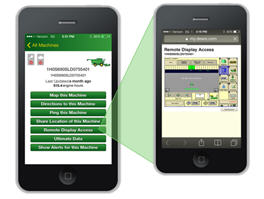 RDA on smartphone
RDA on smartphone
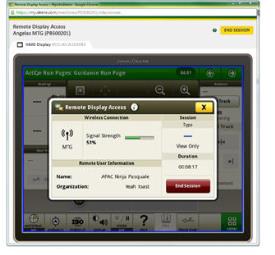 RDA showing 4600 CommandCenter™ Display – remote view
RDA showing 4600 CommandCenter™ Display – remote view
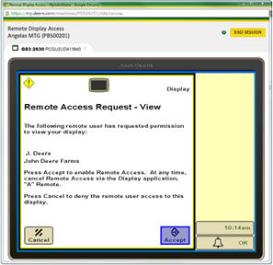 RDA showing GreenStar™ 3 2630 Display – remote view
RDA showing GreenStar™ 3 2630 Display – remote view
Reduce the risk of data loss by wirelessly sending and receiving data
Gen 4 applications and subscriptions allow data to be transferred from the display to the John Deere Operations Center for job reporting and analysis using Wireless Data Transfer (WDT) or Data Sync.
- With WDT, you can manually send data to the John Deere Operations Center for review.
- Data Sync is enabled with purchase of the Premium or Automation Activation/Subscription, automatically sending your data to the Operations Center every 30 seconds, avoiding the need for manually exporting the data.
Wirelessly sending data helps you save time and money while increasing productivity. Wirelessly transfer setup, prescription, and documentation files securely between office, mobile devices, and 4640/4240 Universal Display or 4600/4200 CommandCenter™ Display, eliminating the need for USB transfer. This increases your uptime and productivity, reduces the risk of data loss, and enables easy data sharing and more timely decision making.
Through the John Deere Operations Center, you are in control and can easily share files with a John Deere dealer and other trusted advisers.
NOTE: For users in areas of poor cellular coverage, data is able to be exported using a USB flash drive.
Enable tractor-implement communication through AEF ISOBUS TC-SC compatibility
The Generation 4 CommandCenter™ and Gen 4 Universal Displays display are an AEF ISOBUS compatible display.
An easy plug and play between implements, displays, tractors, and other products is required today in daily business. This is why within agriculture and forestry, an industry standard, ISOBUS, is used for communication between these products.

From the ag industry, the Agricultural Industry Electronics Foundation (AEF) was initiated in 2008 to have a common forum among manufacturers to define the ISOBUS standard further, define and conduct ISOBUS tests, accelerate adoption, label compatible products, and to communicate this to dealers and customers. John Deere is one of the seven founding members of AEF and is very engaged in the organization.
To better ensure ISOBUS compatibility, the AEF developed new functionalities, i.e., auxiliaries (AUX) and Task Controller Section Control (TC-SC,) in addition to the well-known universal terminal (UT). They are also the basis for the certification of ISOBUS products. An ISOBUS functionality can be described as an independent ISOBUS product and the concept is extendable for later additions of functionalities.
Gen 4 CommandCenter and Gen 4 Universal Displays support the following ISOBUS features:
- 4600/4200 CommandCenter and 4640/4240 Universal Display:
- Universal Terminal (UT)
-> ISOBUS sprayer, seeder, planter, fertilizer spreader, manure applicator, and many other implements can be operated through the UT functionality. - Task Controller Section Control (TC-SC)
-> With TC-SC, ISOBUS compliant implements like sprayers, seeders, planters, fertilizer spreaders, and manure tankers can be used with automatic Section Control. - Task Controller Basic (TC-Bas)
-> With TC-Bas, documentation with ISOBUS compliant implements in the standard data format of ISOXML is possible. Also, totals like area, amount, etc. are recorded directly from the implement. - Task Controller geo-based (TC-Geo)
-> With TC-Geo, location-based documentation with ISOBUS compliant implements in the standard data format of ISOXML is possible. Also, Client, Farm, Field, Boundary, Products, Crops (incl. Varieties), Prescriptions, Operators, Tasks, Comments are recorded directly from the implement. - Auxiliary Control (AUX-N)
-> With AUX-N, additional control elements that facilitate the operation of complex equipment, such as a joystick; also, the capability of controlling implement functions by means of an additional control element.
- Universal Terminal (UT)
 Gen 4 system page includes info on ISOBUS compatibility
Gen 4 system page includes info on ISOBUS compatibility
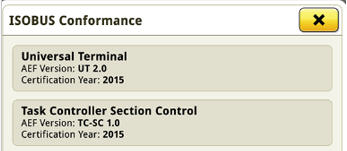 Individual ISOBUS features with details are highlighted
Individual ISOBUS features with details are highlighted
To stay up to speed on which implement and product complies with which ISOBUS features, please visit the AEF website and sign up for the database. It combines tractor, sprayer, and display combination to determine compatibility.
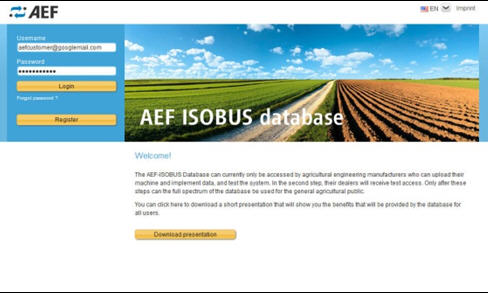 Sign up and log in page to the AEF database – user is able to create an account and check on compatibility for products.
Sign up and log in page to the AEF database – user is able to create an account and check on compatibility for products.
Activate Gen 4 display software remotely
Over-the-air activations were enabled with the 18-1 software update to the Gen 4 displays. With that software update or newer, a John Deere dealer can send activations to a Gen 4 display without leaving the office. Over-the-air activations also eliminate the need to manually enter long activation codes like was done previously. This also eliminates multiple trips between the cab and the farm office to enter codes and verify completion.
NOTE: Over-the-air activations requires a current JDLink™ Connect subscription and Mobile Telematics Gateway (MTG). Planter and platform activations and subscriptions cannot be updated over-the-air.
Features
SeedStar™ 4HP monitoring system
SeedStar 4HP is designed to optimize the in-cab monitoring experience exclusively on the Gen 4 4600 CommandCenter™ display or 4640 Universal Display for growers with ExactEmerge™ planters and MaxEmerge™ 5e planters model year 2018 and newer. With SeedStar 4HP, operators will easily see key planter information with customizable run pages, zoom functionality, and simultaneous graph and performance measurements. SeedStar 4HP is included in base on all model year 2018 ExactEmerge and MaxEmerge 5e planters.
Features overview:
- View multiple planters' at-a-glance bar charts simultaneously
- Three default planter run pages show key planter functions in easy-to-view layouts
- Highly configurable run pages allow SeedStar modules to be customizable
- Zoom feature allows quick row-by-row detailed information
- View dual bar graphs to see multiple planter details at one time
- SeedStar application to make adjustments to planter functions
- Simplified setup through the work set-up page
- Custom rates allow up to six different rates across 48 rows
- The SeedStar 4HP monitoring system requires the Gen 4 4600 CommandCenter or 4640 Universal Display. These displays allow the operator to benefit from the updated interface, enhanced processing speeds, and easy setup (learn more here).
SeedStar 3 HP conversion to SeedStar 4HP with mobile row-unit runoff aftermarket for field conversion kits
Growers who are currently running model year 2017 planters, model year 2017 and newer retrofit kits, or model year 2017 and newer custom-built planters with the SeedStar 3 HP monitoring system can upgrade to the SeedStar 4HP monitoring system with mobile row-unit runoff. The attachment part, AA100382, is software only. The Gen 4 display software version will need to be 19-1 or newer and will require planter apps. Follow the mobile runoff ordering and software push guide below for ordering and installation. Retrofitted planters and custom-built planters will also require the John Deere Connect Mobile kit, 0048PC, from the Precision Ag Technology Price Pages and wiring harness AA83662 to enable the mobile row-unit runoff feature. Please reference Parts Advisor and CCMS Solution 105181 for model-specific mounting brackets. SeedStar 4HP requires the Gen 4 4600 CommandCenter™ v2 display or 4640 Universal Display.
Default planter run pages
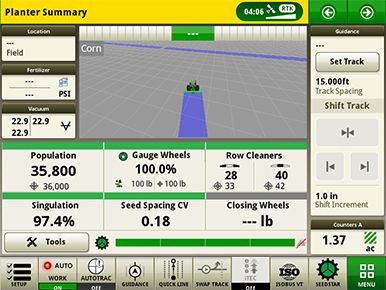 Planter summary default run page
Planter summary default run page
 Planter overview default run page
Planter overview default run page
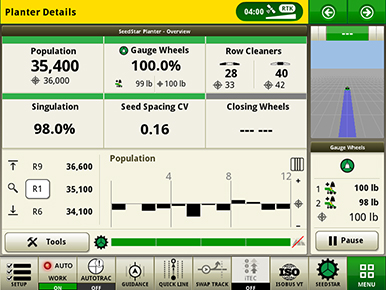 Planter details default run page
Planter details default run page
Three default run pages show key planter functions in different views to give fast and easy access to important planter information.
Custom run pages
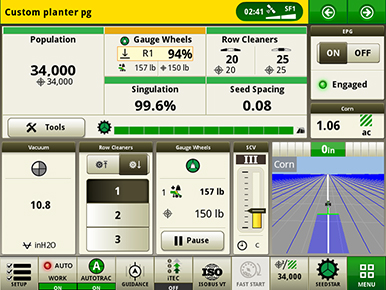 Customizable run pages
Customizable run pages
There are customizable run pages that allow the operator to build pages that fit their operation with different modules, like the example shown above.
Zoom functionality
 Zoom feature showing a group of rows
Zoom feature showing a group of rows
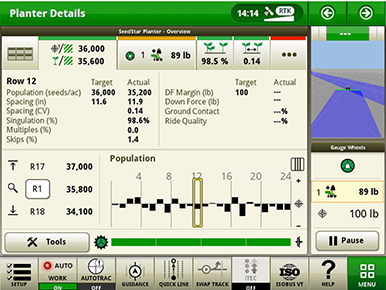 Zoom feature showing a single row
Zoom feature showing a single row
The zoom feature allows the operator to touch a section or row of the planter and get detailed information quickly.
Dual bar graphs
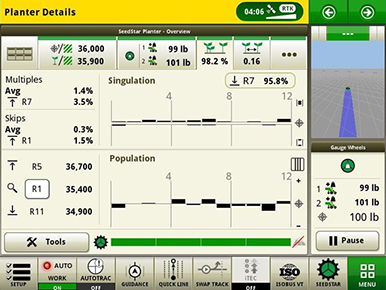 Dual bar graph showing singulation and population simultaneously
Dual bar graph showing singulation and population simultaneously
Dual bar graphs allow operators to view multiple planter details at one time.
SeedStar application page
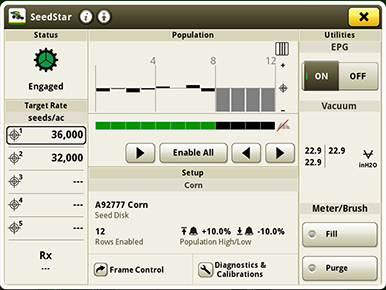 SeedStar application run page
SeedStar application run page
In the SeedStar application, many adjustments can be made, including manually activating section control. SeedStar 4HP allows up to 48 individual row sections. There are several setup features such as crop, seed disk, number of rows being planted, population alarms, and limits. Seed rates can be modified, electric power generation (EPG) can be turned on or off, vacuum can be adjusted, and the fill and purge functions can be used from the SeedStar application. Frame control, as well as diagnostics and calibrations, can be accessed at the bottom of the screen.
Settings Manager in SeedStar 4HP
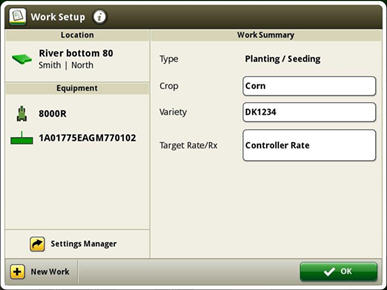 Settings Manager screens
Settings Manager screens
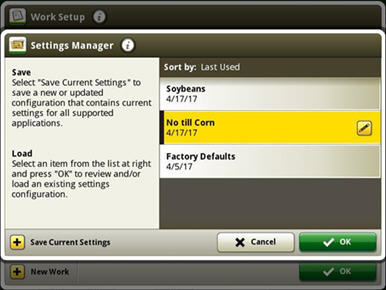
Reduce set-up time between changing crops or field conditions by recalling saved settings used previously with Settings Manager, included with every SeedStar 4HP system. This feature allows saving and recalling planter and tractor settings for optimum performance in different conditions.
Settings Manager can be used to save all of the adjustment and inputs associated to a particular crop or condition. An example would be to store all population rates, downforce pressure, row cleaner adjustments, and closing wheel settings for planting corn and storing a separate, unique set of adjustments for soybeans. In addition, Settings Manager stores tractor settings such as selective control valve (SCV) flow and detents, infinitely variable transmission (IVT™) settings, eco modes, and more.
Custom rates in SeedStar 4HP
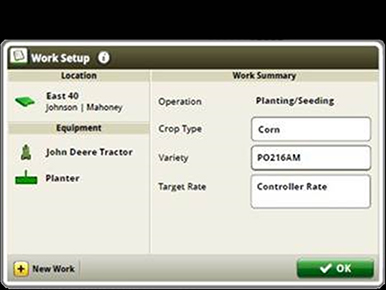 Variety set-up page
Variety set-up page
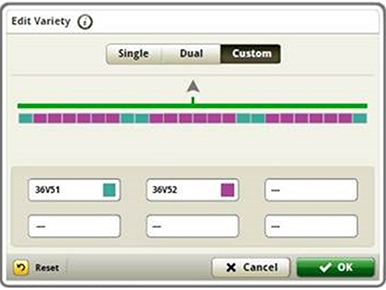 Rate set-up page
Rate set-up page
 Group rate set-up page
Group rate set-up page
Custom rates allow for individual row population control and row-by-row documentation where up to six different rates can be assigned across an up to 48-row planter. This allows growers interested in planting seed corn with ExactEmerge or MaxEmerge 5e the capability to assign specific populations to male and female rows for planting. This feature can also be used to create tram lines or other applications where custom rates by row are needed.
NOTE: Individual rates are tied to varieties, so each individual rate needs a unique variety name.
Compatibility
| SeedStar 4HP compatibility | |
| Planters | All models ordered with ExactEmerge or MaxEmerge 5e row-units NOTE: Retrofit kits are equipped with SeedStar 3HP only, but can be upgraded by purchasing part number AA100382. |
| Displays | Gen 4 4600 CommandCenter equipped with Version 2 Processor or 4640 Universal Display Dual-display mode is compatible with mid model year 2019 planter software. |
| Active Implement Guidance (AIG) | Compatible with SeedStar 4HP on Gen 4 displays with VT mode and required activations and subscriptions |
| AutoTrac™ Implement Guidance | Not compatible |
| AutoTrac Turn Automation | Not compatible |
Additional information
For additional information on feature functionality on the Gen 4 Display, visit the links below:
YouTube is a trademark of Google LLC.
Mobile row-unit runoff
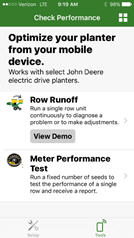 Row Runoff diagnostic test
Row Runoff diagnostic test
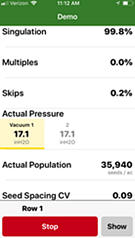 The test functions from a mobile device
The test functions from a mobile device
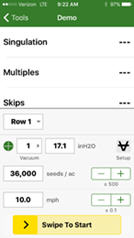 Determine optimum settings without being in the cab
Determine optimum settings without being in the cab
The first day of planting season can be as productive as the last with mobile row-unit runoff. The mobile row-unit runoff activation on the planter main controller (PMC) allows operators to make adjustments to maximize row-unit performance from a mobile device at the rear of the planter for both preseason and in-season use - all enabled through the PlanterPlus™ app.
Mobile row-unit runoff allows growers to perform test-stand functions from a mobile device connected to the planter.
The row runoff test provides complete diagnostic checks both preseason and in season. With the row-unit runoff test, the operator can make adjustments from the mobile device, including vacuum pressure, to determine the optimum meter and vacuum settings. This app functionality will help avoid making trips to the cab while validating meter performance.
During preseason planter inspections and set up, utilize the meter performance test to validate meter accuracy, similar to a test stand without leaving the farm. Test all systems on the planter, not just the meter, providing confidence that all planter systems are ready to plant. Reports are generated from the test providing information the operator can save and send for future reference.
Before heading to the field, the operator will benefit from knowing the best row-unit and vacuum settings for each variety selected to plant that spring.
Watch this video to see mobile row-unit runoff in action.
Mobile row-unit runoff will work with any model year 2015 or newer ExactEmerge™ or MaxEmerge™ 5e equipped planter. Mobile row-unit runoff can be added with attachment AA93169.
For model year 2018 and newer ExactEmerge planters, mobile row-unit runoff is included in base equipment. For model year 2018 and newer MaxEmerge 5e planters not equipped from the factory, mobile row-unit runoff can be added with attachment AA93169. A mobile row-unit runoff and Easy Fold package can be added with attachment AA97849 (only available with 1775NT and 1795 Planters with a 2-point hitch and model year 2019 and newer DB Planters with Gen 4 based frame folding).
NOTE: Mobile runoff utilizes PlanterPlus app available on select iPad® tablets, iPhone® smartphones, and Android™ devices.
Mobile row-unit runoff and Easy Fold aftermarket for field conversion kits
The below software bundles include the functionality explained above for machines not ordered with the feature from the factory. Compatible machines include all the necessary sensors and harnesses needed to make the feature function. The attachment part is software only. Follow the mobile runoff ordering and software push guide below for ordering and installation.
SeedStar™ 3 HP conversion to SeedStar 4HP with mobile row-unit runoff aftermarket for field conversion kits
Growers who are currently running model year 2017 planters, model year 2017 and newer performance upgrade kits, or model year 2017 and newer custom built-planters with the SeedStar 3 HP monitoring system can upgrade to the SeedStar 4HP monitoring system with mobile row-unit runoff. The attachment part, AA100382, is software only. The Gen 4 display software version will need to be 19-1 or newer and will require planter apps. Follow the mobile runoff ordering and software push guide below for ordering and installation. Performance upgraded planters and custom-built planters will also require the John Deere Connect Mobile kit, 0048PC, from the Precision Ag Technology Price Pages and wiring harness AA83662 to enable the mobile row-unit runoff feature. Please reference Parts Advisor and CCMS Solution 105181 for model-specific mounting brackets. SeedStar 4HP requires the Gen 4 4600 CommandCenter™ v2 display or 4640 Universal Display.
Mobile runoff ordering and software push guide
iPad and iPhone are trademarks of Apple Inc. Android is a trademark of Google LLC.
Downforce system options

Heavy-duty adjustable downforce springs
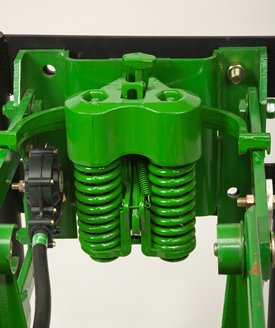 Heavy-duty adjustable downforce spring
Heavy-duty adjustable downforce spring
Planter row-unit downforce is an important factor to ensure consistent and proper depth control. The heavy-duty adjustable downforce feature provides up to 181.4 kg (400 lb) of downforce. There are four settings available to allow the operator to choose the amount of downforce required for the condition: 0 kg (0 lb), 56.7 kg (125 lb), 113.4 kg (250 lb), and 181.4 kg (400 lb).
Compatibility: 1705, 1715, 1725, 1735, 1755, 1765, 1765NT, 1775 Flex, and 1785
Standard pneumatic downforce system
Pneumatic downforce provides convenient, simple adjustment of downforce for the whole planter from one location. The amount of downforce applied is infinitely adjustable from 0 to 181.4 kg (0 to 400 lb). Pneumatic downforce provides more consistent downforce throughout the range of row-unit travel than mechanical spring downforce systems.
Features include:
- 9.5-mm (3/8-in.) air delivery line instead of the 6.4-mm (1/4-in.) line used on model year 2010 and older planters.
- Air compressor assembly increased duty cycle. With this compressor, it provides a 47 percent increase in maximum air flow delivery compared to the prior air compressor.
- Pneumatic air bags with 9.5-mm (3/8-in.) air line inlets that have greater durability.
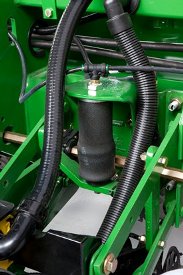 Pneumatic downforce spring
Pneumatic downforce spring
Each row-unit has a single rubber air bag located between the parallel arms. The air bags are hooked in parallel so that air can be added or released from all rows at once from one location.
The individual pneumatic downforce air bag assemblies, air compressor units, and 9.5-mm (3/8-in.) delivery lines are also available as an attachment for field conversion.
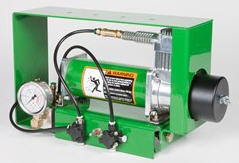 Pneumatic downforce compressor and gauge
Pneumatic downforce compressor and gauge
An improved compressor is used to charge the pneumatic system. This compressor can be located on the planter frame or in the tractor cab if desired. A gauge at the compressor indicates the amount of downforce being applied.
From the factory, integral planter models with pneumatic downforce will have an improved air compressor assembly with an in-cab mounting bracket, except for the 1725 16-row and 1725 Central Commodity System (CCS™) twin-row planters, which will have the air compressor assembly mounted on the planter frame. For drawn planter models, the 1755, 1765, 1765NT, 1775 Front-Fold, and 1785 Drawn Planters will have the air compressor assembly installed either on the outer hitch or wing frame members when the pneumatic downforce system is installed.
Base equipment on: 1705, 1715, 1725, 1735, 1755, 1765, 1765NT, 1775 and 1785.
Integrated pneumatic downforce system
The functional features of the integrated system are the same as the standard pneumatic system, explained above, with the addition of control through the GreenStar™ display.
System control with the GreenStar display
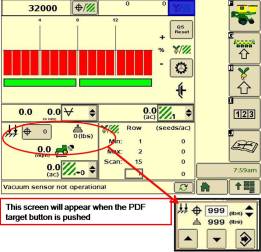 Pneumatic downforce control in GreenStar 2 Display
Pneumatic downforce control in GreenStar 2 Display
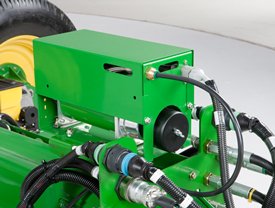 Air compressor mounted on 1775NT outer hitch
Air compressor mounted on 1775NT outer hitch
On 1725 16-row, 1725 CCS TR, 1775NT, 1775NT CCS, 1795, DR, and DB Series Planter models, the air compressor will be mounted on the outer hitch or frame assembly. Since the air compressor assembly is mounted on the outer hitch (as noted in the picture above) or frame, adjustments for row-unit downforce and related system pressures will be made electronically with the GreenStar display.
When adjusting the amount of row-unit downforce using the GreenStar display, the operator will select the amount of downforce (kg [lb]) to be applied across the planter. Depending on the soil conditions at hand, the operator might need to adjust the relative amount of row-unit downforce being applied during the planting operation. The integrated pneumatic downforce controls within the GreenStar display will only allow for set-point operation and not automatic control as the planter is operating in different soil conditions. The pneumatic downforce system does not have the capability to automatically adjust downforce.
On-board air storage
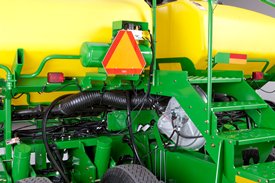 Onboard air storage installed on 1775NT 24R30
Onboard air storage installed on 1775NT 24R30
The 1725 16-row, 1725 CCS TR, 1775NT, 1775NT CCS, 1795, DR, and DB Series planters will have onboard air storage to increase the overall response time when making a row-unit downforce adjustment from the GreenStar display. The onboard air storage is comprised of a 18.9-L (5-gal.) storage tank with valve assembly.
Base equipment on: 1725 CCS, 1725 16-row, 1725T, 1775NT, 1775NT CCS, 1795, DR, and DB Series Planters with MaxEmerge™ 5 row-units. MaxEmerge 5e and ExactEmerge™ equipped planters come with active pneumatic downforce in base.
Active pneumatic downforce
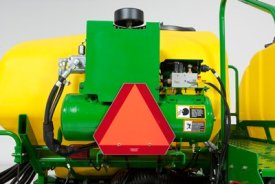 Active downforce compressor assembly
Active downforce compressor assembly
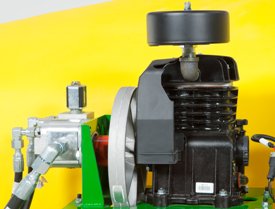 Hydraulic motor
Hydraulic motor
A hydraulically driven compressor works with the SeedStar™ 3 HP system and SeedStar XP system to automate downforce control. Just set the row-unit target margin value and the active pneumatic downforce system works automatically. The system will make sure the planter maintains this value, achieving precise soil penetration, and consistent planting depth, without sidewall soil compaction. From the factory, the system is set at 45.4 kg (100 lb) target downforce margin, but may be modified for varying field conditions. This frees the operator from constantly making manual downforce adjustments as conditions change.
This system offers a split-rank control feature for 1795 and DB Split-Row Planters. On split-row planters, active downforce will control the front and rear rows independently. This compensates for differing downforce requirements between the ranks that can be caused by things like different tillage or insecticide attachments and will help maintain an accurate planting depth and consistent margin across all the rows.
Active pneumatic downforce is available as factory installed or as an attachment for field conversion.
SeedStar XP row-unit downforce planter run page
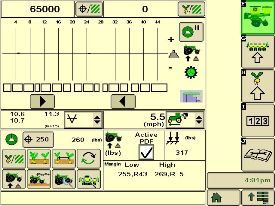 SeedStar XP downforce planter run page
SeedStar XP downforce planter run page
Active downforce control is integrated into SeedStar XP and SeedStar 3 HP monitoring systems.
Margin is the amount of weight riding on the depth gauge wheels that ensures desired firming of the seedbed as set by the operator.
Once a target margin has been defined, enter the value into SeedStar XP or SeedStar 3 HP and let active downforce do the rest. The system will actively adjust the air pressure in the air bags to maintain a constant margin across the planter. The changes in air pressure will change the amount of downforce placed on the row-unit, compensating and reacting for varying conditions through the field whether it is different tillage practices, soil types, or moisture.
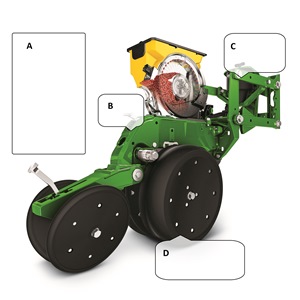 Downforce and margin example
Downforce and margin example
- A - Margin – amount of additional downforce applied to a row-unit above and beyond what is required for penetration to achieve planting depth. This additional weight will ride on the depth gauge wheels. 54.4 kg (120 lb) + 36.3 kg (80 lb) = 90.7 kg (200 lb) – 68 kg (150 lb) = 22.7 kg (50 lb) of margin
- B - Weight of row-unit - 54.4 kg (120 lb)
- C - Downforce – force that is applied to the row-unit by the air bag circuit - 36.3 kg (80 lb)
- D - Resistance from soil - 68 kg (150 lb)
Hydraulically driven compressor
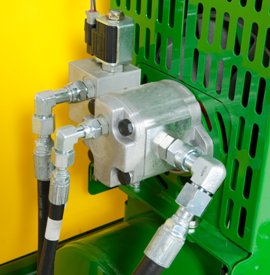 Hydraulic motor
Hydraulic motor
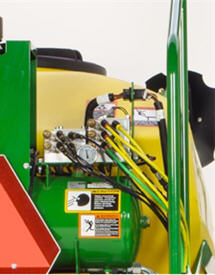 Pneumatic valve
Pneumatic valve
The hydraulically driven air compressor can deliver up to eight times the air flow, allowing for more and faster downforce changes to be made. This more robust design features a 37.8-L (10-gal.) storage tank across all models with active downforce.
At approximately 15.1 L/min (4 gpm), hydraulic demands are low and ties into the machine’s lift and CCS hydraulic circuit so it does not require any additional selective control valves (SCVs). The SeedStar XP and SeedStar 3 HP monitoring systems work with the compressor and valve assembly to regulate air to downforce springs, enabling the active control.
Another feature of John Deere active downforce is the ability for the pneumatic valve to independently control split-rank machines. This system senses the downforce needs from the front and rear ranks separately and independently adjusts air pressures with the dual-rank pneumatic valve when equipped. Active pneumatic downforce requires SeedStar XP or SeedStar 3 HP to enable active control.
Base equipment on: All MaxEmerge 5e and ExactEmerge equipped planter models.
Individual Row Hydraulic Downforce (IRHD)
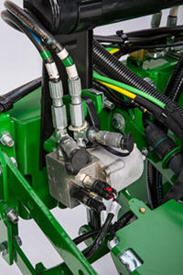
IRHD has been specifically designed to meet the needs of producers that are looking to adjust to the toughest field conditions and provide maximum yield potential from field to field, season after season. IRHD works as a closed-loop downforce system that reacts quickly on an individual row basis to changing soil conditions supporting increased ground contact, which can lead to improved seed depth consistency. When setting planter downforce margin, the system will apply the needed downforce by row to maintain ground contact. From the factory, the margin will be set at 45.4 kg (100 lb), changes may be required based on varying field conditions.
The system allows operators to maintain gauge wheel ground contact leading to desired seed depth placement. IRHD can adjust five times per second and make adjustments of 45.4 kg (100 lb) in less than a second. The system has a total range of applied downforce from 22.7 kg (50 lb) to 204.1 kg (450 lb) and utilizes the power beyond circuit on the tractor. IRHD is 58 percent faster than the active pneumatic downforce solution. Fast reaction and increased ground contact can lead to improved emergence. With uniform emergence, some studies have shown a yield impact from 5 percent to 9 percent.
IRHD is controlled through the Gen 4 4600 CommandCenter™ Display or 4640 Universal Display with SeedStar 4HP. As shown below, operators can view ground contact or applied downforce using the toggle button.
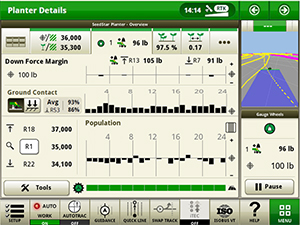 IRHD screen showing the ground contact graph
IRHD screen showing the ground contact graph
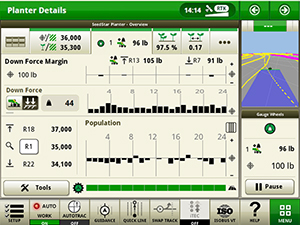 IRHD screen showing the applied downforce graph
IRHD screen showing the applied downforce graph
Optional equipment on: 1775NT, 1795, DB, and Orthman custom models with MaxEmerge 5e and ExactEmerge row-units.
Easy Adjust row cleaners
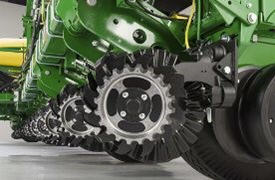 Coulter combo row cleaner
Coulter combo row cleaner
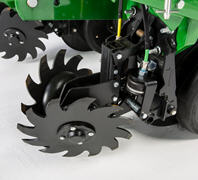 Easy Adjust row cleaner
Easy Adjust row cleaner
Easy Adjust row cleaner and coulter combo provides a pneumatic row tillage solution that is controlled from the seat of the tractor.
Every decision to make an adjustment during spring planting reduces the acres planted per day and can increase or decrease profitability. An adjustment that can be overlooked is row cleaners due to planter size, difficulty to make the adjustment, and varying conditions across fields and time.
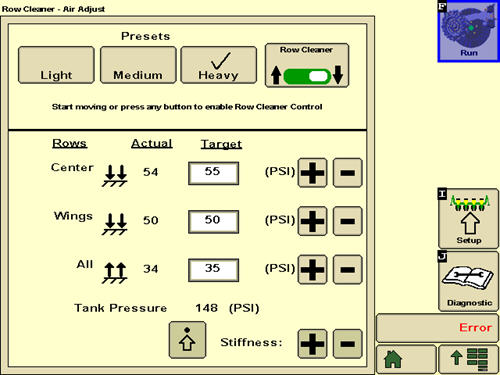 GreenStar™ 3 2630 Display view for row cleaners compatible with SeedStar™ 3 HP
GreenStar™ 3 2630 Display view for row cleaners compatible with SeedStar™ 3 HP
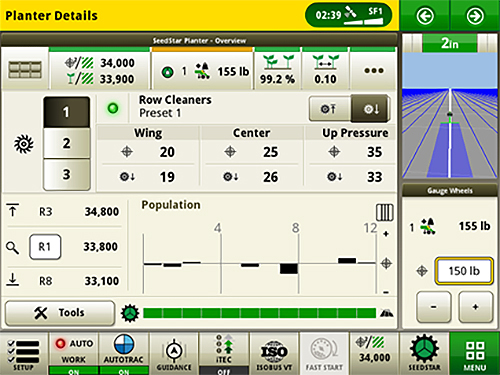 4600 CommandCenter™ Display and 4640 Universal Display view for row cleaners compatible with SeedStar 4HP
4600 CommandCenter™ Display and 4640 Universal Display view for row cleaners compatible with SeedStar 4HP
With the Easy Adjust row cleaners on ExactEmerge™ planters, operators now have a pneumatic solution to make on-the-go adjustments that is controlled directly from the seat of the cab. They can be raised from the cab as needed with the push of a button for wet areas, waterways, or end rows. For growers using SeedStar 3 HP, the row cleaners are completely integrated into the John Deere GreenStar 3 2630 Display as well as the Gen 4 4600 CommandCenter display or 4640 Universal Display. For growers using SeedStar 4HP, a 4600 CommandCenter display or 4640 Universal Display is required.
The Easy Adjust row cleaners have the capability to save three presets for varying ground engagement based on field conditions. The system is controlled in three sections: at each wing as well as the center (frame or wheel) track rows. The pneumatic lines use air from the active pneumatic downforce compressor, requiring no additional compressor to be installed on the planter. The Easy Adjust row cleaners utilize down and up force air bags. The adjustable air pressure setting for each bag allows the operator to set the ride of the row cleaner depending on the field conditions and the desired results. Making these on-the-go adjustments from tractor cab increases productivity and performance during planting.
For Easy Adjust row cleaner performance upgrade kit options, see the ordering guide.
The row cleaner-only option utilizes parallel linkage to provide the floating action growers require in their fields. Parallel linkage allows for the unit to float up and down in the situation of hills or hard objects. The cleaner and coulter combo does not have parallel linkage, however, the row cleaners have floating rings installed to help provide the same benefits.
The row cleaners utilize the field-proven SharkTooth® design. Row cleaners play a major role in maximizing yield toward uniform emergence, reducing row-unit bounce, and maintaining proper depth. The Easy Adjust row cleaners provide growers with quick and stress-free solutions to customizing the planter in variable field conditions. They are available on ExactEmerge and MaxEmerge 5e equipped planters. They are not integrated into the RowCommand™ feature.
SharkTooth is a trademark of Yetter Manufacturing Incorporated.
Pneumatic closing wheels

Pneumatic closing wheels are compatible with MaxEmerge™ 5e and ExactEmerge™ row-units. They are available on the following models from the factory: 1775NT, 1795, and DB60 models. The pneumatic closing wheels give operators the ability to adjust closing wheels in seconds without leaving the cab of the tractor.
Using the GreenStar™ 3 2630 Display, pneumatic closing wheels can be adjusted to 25 different positions. From the factory the system is setup with two sections, the outer wings and center frame. With this system, producers will see up to a 76 percent increase in consistent force applied at the closing wheel. Consistently applying the correct force at the seed trench is one of the key elements of supporting improved emergence. Studies show potential yield impact on corn from even emergence from 5 percent to 9 percent*.
NOTE: Pneumatic closing wheels can be purchased for existing MaxEmerge 5e and ExactEmerge planters as an aftermarket field kit. Both rubber tire and cast-iron closing wheels are compatible.
Access the pneumatic closing wheels attachment for field conversion (AFC) ordering guide to fit a 1725 CCS, 1775NT, 1795, or DB60 Planter.
*Planting Outcome Effects on Corn Yield: Doerge, Tom, Jeschke, Mark and Carter, Paul
Curve compensation
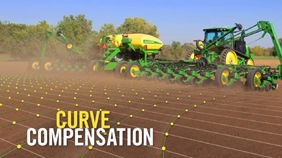
Terraces or waterways are two of many field obstacles that make planting on a curve challenging. When planters utilize drive shafts, they are not able to control each individual row-unit; as a result, planting on a curve presents an issue of maintaining 100 percent population. Since the inside rows are moving slower than the outside rows, the inside rows will be over populating while the outside rows are under populating.
With ExactEmerge™ planters and equipped MaxEmerge™ 5e planters, the curve compensation feature allows each row to receive an individual signal based on the speed at which the row-unit is moving, maintaining the correct population across the width of the planter. Without curve compensation, there could be as much as a 24 percent drop in population accuracy, which is equivalent to 8,600 seeds per acre when planting at 36,000 seeds per acre. Curve compensation measures acceleration within the main planter controller and utilizes speed inputs to ensure each row has the desired population accuracy.
Row cleaner options to meet residue management needs
Crop yields have increased through the years along with the amount of residue left in the field after harvest. At the same time, tillage practices have changed, including different tillage operations which maintain large amounts of surface residue, and even no-till practices. Row cleaners are an essential tool in managing this increased amount of residue.
John Deere seeding group offers a variety of row cleaner options to meet the needs of a producer's operation. Compatibility varies by model, row spacing, and other planter equipment.
Screw-adjust, unit-mounted row cleaner
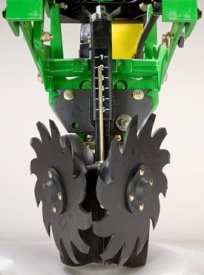 Screw-adjust, unit-mounted row cleaner
Screw-adjust, unit-mounted row cleaner
The screw-adjust, unit-mounted row cleaner is mounted directly to the face plate of the row-unit, placing the ground engaging components just in front of the row-unit opener blades and depth gauge wheels. This close proximity allows the gauge wheels to control the depth of the row cleaner as well as the row-unit. This compact design also allows greater compatibility with fertilizer openers and other planter attachments.
SharkTooth® wheels are standard equipment on the unit-mounted row cleaner. The swept-tooth design of the wheel provides a clear path for the row-unit openers while resisting residue buildup on the wheel. The screw adjustment knob is accessible through the top of the parallel arms, providing convenient access for adjustments. The row cleaner can be adjusted in 1.6-mm (1/16-in.) increments, providing plenty of flexibility to meet the needs of changing conditions.
Floating row cleaner with unit-mounted coulter
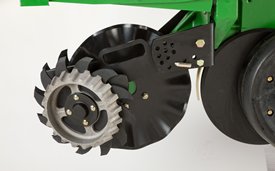 Floating row cleaner with unit-mounted coulter
Floating row cleaner with unit-mounted coulter
The floating row cleaner allows a row cleaner to be used in conjunction with a unit-mounted coulter. This combination is often desired in heavy residue loads and reduced tillage planting conditions. The row cleaner provides a clear path for the row-unit, while the unit-mounted coulter helps penetrate tough soil conditions.
Accommodating the unit-mounted coulter means the residue wheels are farther forward from the row-unit face plate than in the case of the screw-adjust row cleaner. To maintain performance, this row cleaner has the capability to float above a defined minimum depth.
Standard depth-gauging bands on the wheels allow the row cleaner wheels to float independently of the row-unit openers, allowing both to perform in varying terrain. The unit may also be set in a fixed position by simply pinning through the bracket if desired. This row cleaner also features SharkTooth wheels as standard equipment.
The floating row cleaner and unit-mounted coulters are available on many planters as factory-installed equipment. As compatibility and details vary by model, review the following links for information on specific planter models.
NOTE: Screw-adjust row cleaners are not compatible with MaxEmerge™ 5e row-units with long parallel arms.
NOTE: DB models have the option for either unit-mounted coulter, screw-adjust row cleaners, or pneumatic row cleaners (only compatabile with MaxEmerge 5e or equipped ExactEmerge™ models). The DB60T is only available with a less row cleaner option.
SharkTooth is a trademark of Yetter Manufacturing, Inc.
RowCommand™ individual-row control system
RowCommand controls seed output
 RowCommand on a MaxEmerge™ 5 row-unit
RowCommand on a MaxEmerge™ 5 row-unit
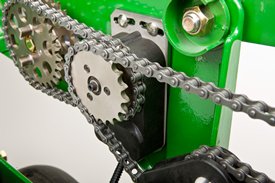 RowCommand on a chain drive MaxEmerge 5 row-unit
RowCommand on a chain drive MaxEmerge 5 row-unit
Controlling input costs and improving productivity are key producer requirements today. RowCommand is an effective, integrated John Deere solution designed to meet these intensifying needs. The RowCommand system manages seed output, reduces yield drag, and improves harvest capabilities on all Pro-Shaft™ driven row-units, and chain-driven MaxEmerge 5.
NOTE: Chain-drive RowCommand is only compatible with planters equipped with pneumatic downforce systems. On planters equipped with the heavy-duty downforce springs, potential chain interference may result and is not recommended.
NOTE: Chain-drive RowCommand requires some modification to brackets in order to function with corn finger pickup meters.
NOTE: Pro-Shaft drive RowCommand is compatible on MaxEmerge 5 row-units with vacuum and corn finger pickup meters. For mini-hopper row-units, RowCommand is compatible on vacuum meters only and is not compatible on corn finger pickup meters. Pro-Series™ XP row-units with corn finger pickup meters are not compatible with RowCommand.
RowCommand controls seed output by incorporating individual, low amperage clutches inside the Pro-Shaft and chain-driven gearboxes. Clutches are completely enclosed within the gearbox housing to protect them from the elements and harsh operating conditions.
When power is supplied, either manually or through John Deere Section Control software, clutches disengage the seed meters and seed flow stops. Controlling seed output at individual rows reduces overplanting in point rows and maximizes seed placement when entering/exiting headlands.
Components and operation
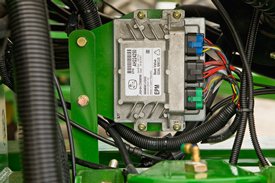 Electronic power modules shown on a 1775NT Planter
Electronic power modules shown on a 1775NT Planter
 RowCommand clutch on MaxEmerge 5 with 105.7-L (3-bu) hopper
RowCommand clutch on MaxEmerge 5 with 105.7-L (3-bu) hopper
RowCommand is a simple and efficient solution to control individual row planting. This system does not utilize air to operate; therefore, no compressor, air lines, or valve modules are required.
RowCommand utilizes low-voltage controller area network (CAN) messaging to signal power to the desired clutches to stop planting or eliminates power to resume planting.
This means very little power is used in normal planting conditions, and in the event a clutch fails electrically, the meter will continue to plant.
The RowCommand system requires the following five basic components to operate:
-
Electric clutches
-
Electronic power modules (EPMs)
-
SeedStar™ 2 monitoring (wedge box/controller)
-
GreenStar™ (GS) display
-
Planter wiring harnesses
Clutches are protected within the sealed Pro-Shaft and chain-driven gearboxes for years of trouble-free operation and simple installation or removal. RowCommand has true individual-row control of up to 16 clutches or sections for planters larger than 16 rows.
Unique to RowCommand, the 16 available control sections can be configured based on operator preferences. For example, on a 1775NT 24-Row Planter, every two rows can be paired together for a total of 12 control sections, or control the outermost eight rows individually and the remaining inner rows paired together for 16 control sections.
While SeedStar with RowCommand has 16 control sections, a minimum of 152.4-cm (60-in.) wide sections are recommended for optimum Swath Control Pro™ solution capabilities. As with other Swath Control Pro products, an SF2 signal is the minimum level of accuracy recommend for operation.
Pro-Shaft drive RowCommand planters
RowCommand is available as a factory-installed option or as an attachment for field conversion attachments for the following Pro-Shaft drive planter models (see chart below).
| Planter model | Row configuration |
| 1725 | 12-row narrow, 12-row wide, and 16-row narrow |
| 1725 Central Commodity System (CCS™) | 16-row narrow |
| 1765 | 12-row narrow |
| 1775 | 12-row narrow |
| 1775NT | 12 row, 16 row, and 24-row narrow |
| 1775NT CCS | 12 row, 16 row, and 24-row narrow |
| 1795 | 12/23 row, 12/24 row, 16/31 row, and 16/32 row |
| 1795 | 24 row, 50.8 cm (20 in.) |
| DB 44 | 24 row, 55.9 cm (22 in.) |
| DB 58 | 32 row, 55.9 cm (22 in.) |
| DB 60 | 36 row, 50.8 cm (20 in.) or 47 row, 38.1 cm (15 in.) |
| DB 66 | 36 row, 55.9 cm (22 in.) |
| DB 80 | 32 row, 76.2 cm (30 in.) or 48 row, 50.8 cm (20 in.) |
| DB 88 | 48 row, 55.9 cm (22 in.) |
| DB 90 | 36 row, 76.2 cm (30 in.) |
| DB 120 | 48 row, 76.2 cm (30 in.) |
| DR (Deere/Orthman™ planter) 16R40 | 16 row, 101.6 cm (40 in.) |
| DR (Deere/Orthman) 18R38 | 18 row, 96.5 cm (38 in.) |
Chain-drive RowCommand planters
In terms of planter compatibility, RowCommand for chain drive is designed for the following planter model configurations equipped with pneumatic downforce systems.
| Planter model | Row configuration |
| 1725 | 12-row narrow, 12-row wide, and 16-row narrow |
| 1765 | 12-row narrow |
| 1775 | 12-row narrow |
| 1775NT | 12 row and 16 row |
| 1775NT CCS | 12 row and 16 row |
| DB 44 | 24 row, 55.9 cm (22 in.) |
Chain-drive RowCommand and heavy-duty downforce
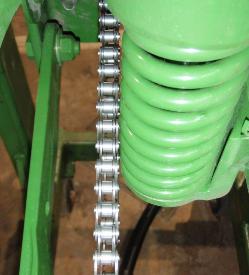 Chain interference with heavy-duty downforce
Chain interference with heavy-duty downforce
As seen in the image, chain interference may result when operating chain-drive RowCommand on planters equipped with short and long parallel arms and heavy-duty downforce springs.
NOTE: Chain-drive RowCommand is only compatible with planters equipped with pneumatic downforce systems. On planters equipped with the heavy-duty downforce springs, potential chain interference may result and is not recommended.
Chain-drive RowCommand with corn finger pickup meters
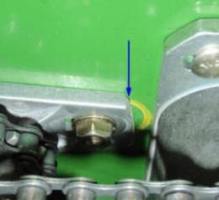 Bracket material removal
Bracket material removal
Due to the design characteristics of the chain-drive RowCommand clutch, some modification to the corn finger pickup meter drive bracket is required. As seen in the picture to the left, some material needs to be removed from the front of the meter drive bracket in order for the chain-drive RowCommand clutch to have sufficient space for installation.
NOTE: Chain-drive RowCommand requires some modification to brackets in order to function with corn finger pickup meters.
RowCommand ordering information
To add RowCommand to a model year 2009 and newer planter model listed above is simple. Pro-Shaft drive attachments for field conversion and chain-drive attachments for field conversion are available by planter model to add the appropriate number of clutches, EPMs, brackets, hardware and row-unit harnesses. For complete installation and part detail for the RowCommand conversion, please use the RowCommand compatibility tool per specific planter model.
RowCommand is compatible and available for model year 2003 (serial number 700101) to 2008 (725101) planter models listed above. In addition to the attachment for field conversion attachment, a planter mainframe harness, SeedStar 2 controller (wedge box), and additional CAN harnesses are needed.
Integrated Swath Control Pro
Coupling RowCommand with Swath Control Pro provides the ultimate in precision planting and productivity. One company, one integrated solution are what we offer by incorporating Swath Control Pro capabilities within the SeedStar 2 wedge box (controller). Unlike previous systems, no rate controller, additional harnessing, or components are required to achieve automated individual-row control.
SeedStar 2 monitoring, RowCommand, and Swath Control Pro activation from John Deere Precision Ag Technologies are all that is needed when ordering.
System requirements
RowCommand is a simple and efficient means to control individual row planting through the use of low-voltage electric clutches. When activated, each clutch consumes no more than 0.5 amps. By design, power is only supplied to the clutch when a signal is received to stop planting. In a normal planting condition, no power is supplied and the clutch is de-energized.
Power for the RowCommand system is provided from the 9-pin ISO implement connector. All late-model 8X00 and 9X00 Series John Deere Tractors equipped with the 9-pin ISO implement connector are capable of supplying ample power for system operation.
Along with ample system power, a GreenStar display and SeedStar monitoring are required for operation and control interface. The GreenStar display is where system setup, control settings, and manual control functions are performed.
Seed variable-rate drive (VRD) with half- or three-width disconnect
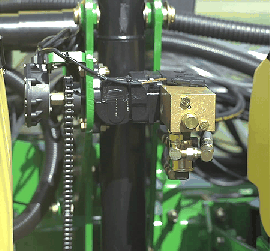 VRD shown on a 1775NT
VRD shown on a 1775NT
The seed variable-rate drive provides the ultimate planting productivity by utilizing one, two or three hydraulic motors (varies by model) to turn the seeding drive shaft. Hydraulic control of the seeding drive allows for on-the-go seeding rate changes right from the display mounted inside the tractor cab.
Combine this seeding flexibility with the map-based planting option, and seeding rates adjust automatically based on a prescription map.
Single- or dual-motor systems for variable-rate drives are available for all John Deere planters except the 1785 Rigid Frame. Dual- or three-motor drive systems are commonly used on larger (12-row and more) planters and offer the capability of half-width or three-section drive disconnect.
The VRD is available as a factory-installed option for all applicable planter models. Single- or dual-motor systems are available as field-installed attachments for most planter models; however, a three-motor VRD field-installed attachment is not available.
The seed VRD requires the SeedStar™ monitor and a radar input signal. Either tractor or planter radar may be used. Planter radar is ordered separately.
VRD offers the following advantages over common, contact-tire drive systems:
-
Almost instantaneous rate changes – there is no ramp up or ramp down of system as in some competitive systems
- Permits the operator to match seed population based on different soil types or irrigation practices
- John Deere design that provides added operator safety by eliminating any possible drive creep found in some competitive variable rate drive systems
Half-width drive disconnect
The half-width drive disconnect feature is excellent for the producer concerned with controlling seed costs. This feature helps the operator place seed in the desired area and limit the amount of costly overlapped planting.
The half-width drive disconnect allows the operator to turn off half of the planter at a time for planting end rows, point rows, etc. Variable-rate-equipped planters require two drive motors to utilize the half-width disconnect feature.
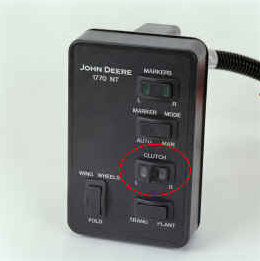 Half-width drive disconnect within frame control
Half-width drive disconnect within frame control
With a 1765, 1765NT, and 1775 12-Row Planter, a single switch box is required for planters that are ordered with variable rate drive and half-width disconnect.
For the 1775NT, 1775NT Central Commodity System (CCS™), and 1795 Front-Folding Planters, the half-width drive disconnect switch is contained within the frame control box, conveniently located in the tractor cab. The function easily shuts off the drive for the left or right half of the planter row-unit seed meters.
Three-width drive disconnect
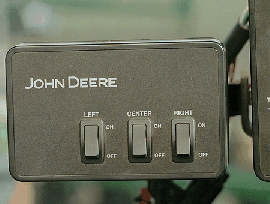 Three-width drive disconnect control
Three-width drive disconnect control
Three-width drive disconnect is an option on 1725 12-Row Planters and is base equipment on the 1725 16Row30 Planter. This feature is activated by three individual console mounted switches (control box), conveniently located in the tractor cab. The function easily shuts off the planter row-unit seed meters by one-, two-, or three-drive segments independently.
Drawbar hitch
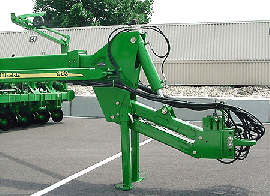 Drawbar hitch
Drawbar hitch
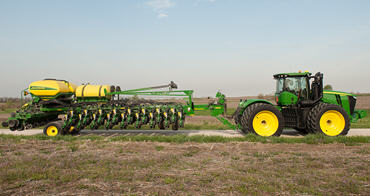
A factory-installed, optional drawbar hitch is available for use with 1775NT 16- and 24-Row, 1775NT Central Commodity System (CCS™) 16- and 24-Row, and 12.2-m (40-ft) 1795 Planters. For all DB models the drawbar hitch is in base. All DB models are available with Category 5 drawbar hitch. The following DB models are not available with Category 4 drawbar hitch: DB80 48R20, DB88 48R22, DB90 36R30, DB90 54R20, and DB120 48R30.
The planter drawbar hitch provides easy operation with plenty of ground clearance. The hitch design utilizes a hydraulic cylinder to raise the planter hitch for transport. Hydraulic oil for the hitch cylinder on 1775NT and 1795 Planters comes from the row marker system. Activation of this cylinder is accomplished using a single switch on the display and the marker selective control valve (SCV).
Due to the hydraulic system design, the drawbar hitch requires the planter be equipped with independent markers (not tied to planter lift circuit). Removal of markers from all planters, except the 1775NT 24Row30, makes the drawbar hitch inoperable. The 1775NT 24Row30 is the only planter where the drawbar hitch, less markers, is a valid combination.
For planting on 38.1-cm (15-in.) row spacing with a 16/32-Row 1795 Planter, the drawbar needs to be offset 19-cm (7.5-in.) on the tractor to center the planting rows behind the tractor. When the 16/32 1795 has a drawbar hitch, operators may not be able to offset the hitch to the exact specifications of 19-cm (7.5-in.) when planting in 38.1-cm (15-in.) operation, and could be off as much as a 1.3-cm (0.5-in.). To compensate, additional adjustments to the marker will be necessary.
When using a guidance system such as parallel tracking or AutoTrac™ assisted steering system, operators will need to use their implement offset when planting with all rows on 1795 Planters equipped with the drawbar hitch to compensate for the offset.
The drawbar hitch is ideal for those who have 9000 Series Tractors without a 3-point hitch. For these, the planter drawbar hitch is the economical choice instead of adding a 3-point hitch.
To accept the planter drawbar hitch, the tractor drawbar must be ordered with, or upgraded to, a Category 4 drawbar with the heavy-duty package or Category 5 to be compatible. Track tractors with wide-swinging drawbars are not compatible with the planter drawbar hitch due to a lower hitch-load capacity.
Each 1795 or 1775NT Planter ordered with the drawbar hitch will be shipped with a Category 4 hitch link installed. A Category 5 hitch link is also shipped with the planter if the planter is to be used with a Category 5 drawbar. See pre-delivery instructions included with the planter for changeover information.
Compatibility:
- Category 5 implement hitch links are not compatible with Category 4 tractor drawbars.
- Category 5 tractor drawbars are not compatible with Category 4 implement hitch links.
This hitch also adds 0.6-m (2-ft) to planter length during transport and field operation. There are some combinations of planter options that are not compatible with the drawbar hitch option due to tractor drawbar limitations.
DB fertilizer options
Option code 2625 – Liquid fertilizer with row-unit mounted in-furrow applicator:
- This option contains a ground driven pump, plumbing to a manifold, and routing to each row-unit. The in-furrow applicator places fertilizer after the seed and before the closing wheels.
The DB60 24Row Split 47 Planter and DB60 24Row Split 48 Planter applies fertilizer on 76.2-cm (30-in.) row spacing only.
Central Commodity System (CCS™) seed delivery system
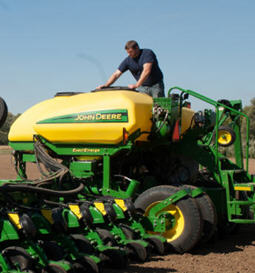 CCS
CCS

CCS seed delivery adds productivity through increased seed capacity, bulk fill capability, and easy, thorough cleanout.
The two tanks have a combined capacity of 2466.7 L (70 bu) on 9.1-m (30-ft) planters and 3523.9 L (100 bu) on 12.2-m (40-ft) and larger planters. CCS tanks are manufactured using a rotomolded, polyethylene design to ensure maximum durability. The translucent tanks allow easily viewing the amount of seed in the tanks. The tanks are separated by 54.6 cm (21.5 in.) for enhanced rear visibility during transport and backing.
The following crops can be planted with CCS: corn, sweet corn, popcorn, cotton, sunflowers, sugar beets, soybeans, and sorghum (milo).
Filling the tanks is convenient due to a central filling location. The staircase and railing provide access to the filling platform between the tanks. If filling the tanks with an auger, minimum recommendations are a 15.2-cm (6-in.) diameter, 4.3-m (14-ft) auger. Each tank has an adjustable bin-level sensor to alert the operator when it is time to fill.
A standard fill light package is available on machines equipped with CCS. This feature includes two lights conveniently mounted on the railings of the machine. The lights are turned on and off with their own switch located at the bottom of the staircase.
If the seed-carrying vehicle requires hydraulic power to run the unloading system, the auxiliary hydraulic coupler option is available. These couplers are located at the bottom of the staircase and can be coupled under pressure. The system has a separate system filter that ensures the planter hydraulic system remains free of contaminates.
Seed delivery process
CCS is about reducing the time spent filling the planter with seed while maximizing the time spent planting. CCS for planters is a form of seed handling and delivery. The row-units perform the final task of seed metering and placement.
The CCS seed delivery process relies on a hydraulically-driven fan to move seed from the CCS tanks to the row-units. This fan is plumbed in to the planter's raise/lower circuit, so only one selective control valve (SCV) is needed for both functions. When the planter is lowered, lift cylinders bottom out and hydraulic flow is diverted to the seed delivery fan. A flow control valve and gauge, located near the tank, allows for the proper tank pressure setting based on seed type.
Air from the fan pressurizes the CCS tanks and delivers seed to the seed hoppers. Airflow enters the seed tanks through a nozzle in the manifold which pressurizes the tank. The air then picks up seed and moves it out the other end of the nozzle into seed delivery hoses. These hoses route the seed toward the hopper. A small amount of seed is traveling in the delivery hoses only when needed.
The hopper fills with seed until the delivery hose (discharge elbow) is covered. Once the opening is restricted, seed flow through the hose stops. Air flowing to the row-unit travels into the hopper and is the source of air for the vacuum system. This provides a much cleaner air source than previous meter designs. As the seed is picked up by the meter and planted, the seed pool shrinks until the end of the delivery hose is uncovered. At that time, the airflow and seed delivery resume and the seed pool in the hopper is replenished.
CCS tank scales for DB Planter models
The CCS tank scales for DB models are a stand-alone system from Digi-Star®. Load cells are installed at the factory and can be ordered for CCS or CCS with Refuge Plus.
There are three load cells, two at the rear of the CCS cradle and one at the front. They weigh both tanks as one; individual tank weights cannot be determined.
The load cells and display are made by Digi-Star. They are not on the controller aread network (CAN) bus system so they are not integrated into SeedStar™ software in any way. The monitor is sold separately through Digi-Star.
CCS seed cleanout
Seed cleanout could not be much easier with a CCS planter. When finished planting, any remaining seed can simply be removed via access doors at the bottom of the CCS tank.
Because seed is only traveling through the CCS delivery hoses when required by the meter, there is not much left to clean.
CCS seed delivery hoses are then purged with air from the CCS fan, and the excess seed is pushed to the individual meters. The vacuum meter door is opened and seed is removed with the supplied catch pan.
Small seed CCS components
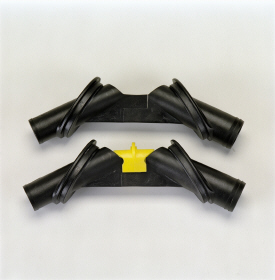 Manifold nozzle and nozzle with cover installed
Manifold nozzle and nozzle with cover installed
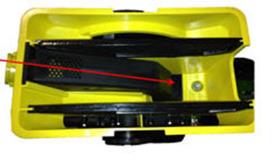 Straight seed inlet installed in mini-hopper
Straight seed inlet installed in mini-hopper
CCS seed delivery system increases planting productivity across the seven approved crops listed above. While highly effective delivering seed from the CCS tanks to the vacuum meters, small or light seeds (sorghum and small cotton) will require two additional components to aid in proper seed delivery.
Manifold nozzle covers (clips) should be installed to ensure seed is adequately picked up into the air stream for delivery to the row-unit. Mini-hopper discharge elbows should also be changed from the standard elbow (holes) to the small seed elbow (slotted openings) when planting sorghum (milo) and small cotton.
Digi-Star is a trademark of Digi-Star LLC.
Provide added versatility and productivity with Central Commodity System (CCS™) Refuge Plus planter configuration

DB44, DB60, DB60T, DB66, DB80, DB88, DB90, and DB120 Planters can be equipped with the Refuge Plus option from the factory.
The third tank on the Refuge Plus system provides increased versatility and productivity to the planting operation by allowing the grower to plant two different varieties simultaneously. The Refuge Plus tank has manifold nozzles, or outlets, to supply seed to eight different row-units.
Refuge Plus is ideal for the grower planting Bt corn or seed corn. Refuge Plus is the solution for refuge management compliance issues associated with Bt corn production. The 881-L (25-bu) capacity of the third tank makes planting the required 20 percent refuge of non-Bt corn easier while maintaining high productivity levels of the central-fill CCS.
For example, Bt corn planted on 80 percent of the field goes into the larger CCS tanks. The required 20 percent refuge, non-Bt corn, goes into the third Refuge Plus tank with the seed hoses routed to the desired rows.
Central fill with CCS is easier for the seed-corn grower as well. The seed-corn grower can plant both male and female seed in the desired pattern simply by placing the male seed in the Refuge Plus tank, the female seed in the CCS tanks, and routing the seed delivery hoses to the desired row units.
NOTE: Only DB44, DB60, DB60T, DB66, DB80, DB88, DB90, and DB120 Planters can be equipped with the Refuge Plus option from the factory. Other CCS equipped models can add Refuge Plus through Parts.
Redirecting seed delivery
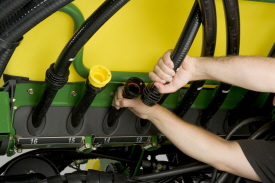 Seed delivery hose connection and yellow plug
Seed delivery hose connection and yellow plug
Redirecting seed delivery from the CCS tanks to the Refuge Plus tank is fast and easy with quick-disconnect couplers. By simply disconnecting the desired CCS delivery hoses from beneath the CCS tank, capping those hoses and reconnecting the delivery lines to the Refuge Plus tank, the seed delivery source is changed.
Due to the additional weight Refuge Plus places on the planter frame, liquid fertilizer tanks are not compatible. Updated liquid insecticide tank codes have been established for Refuge Plus planters.
SeedStar™ 3 HP monitoring system
SeedStar 3 HP overview
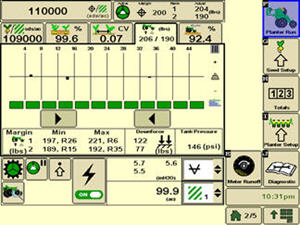 SeedStar 3 HP shown on the GreenStar™ 3 2630 Display
SeedStar 3 HP shown on the GreenStar™ 3 2630 Display

Building upon the foundation of previous SeedStar monitoring, the SeedStar 3 HP monitoring system takes planter monitoring to the next level. When paired with the GreenStar 3 2630 Display, the SeedStar 3 HP monitoring system provides critical information about the planting process to the operator within the tractor cab. SeedStar 3 HP is compatible with the GreenStar 3 2630, the Gen 4 4200 CommandCenter™ Display, the Gen 4 4600 CommandCenter Display, the 4240 Universal Display, and the 4640 Universal Display. SeedStar 3 HP is not compatible with the Gen 4 Extended Monitor.
Detailed planter performance information allows the operator to make adjustments needed for planter optimization. After all, with rising costs, it is imperative to make sure that every seed is planted accurately and precisely within the seed furrow for maximum yield potential.
The SeedStar 3 HP planting functions are fully integrated with the full spectrum of Precision Ag Technology applications such as John Deere Section Control for Planters, GreenStar 3 2630 Display, AutoTrac™ assisted steering system, John Deere Operations Center, JDLink™ telematics system, and others. Integrated planting technologies, for better asset utilization and ease of use, is just part of what SeedStar 3 HP provides.
SeedStar 3 HP main run page
 SeedStar 3 HP main run page
SeedStar 3 HP main run page
SeedStar 3 HP has an updated main run page layout. With the use of tabs toward the top of the screen it is much easier to navigate through readings such as population, singulation, spacing, downforce, and ride quality. If for some reason an issue arises with a row-unit, the tab will turn red indicating there is an issue. The tab can be pushed and lead to what is causing the issue. Inside each tab, there will be a bar graph detailing information specific to that tab. The picture shows what a population bar graph looks like. This layout improves functionality and overall ease of use while planting.
SeedStar 3 HP seed singulation monitoring
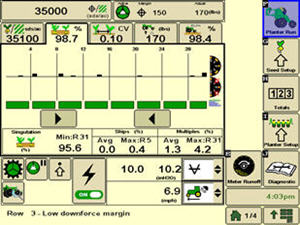 SeedStar 3 HP seed singulation planter run page
SeedStar 3 HP seed singulation planter run page
Understanding meter singulation performance on the planter is critical to minimizing the amount of seed multiples and skips. As a result, the SeedStar 3 HP monitoring system provides real-time information, from the redesigned seed sensors placed in each belt cartridge, about the overall seed singulation performance.
As seen in the screen shot image to the left, overall singulation performance is seen in the tab at the top of the screen. Seed skip and multiple sources of information are displayed below the bar graph of the run page. This provides the operator a better understanding of relative seed multiple and skip data on a row-unit basis within one easy glance at this run page.
Also, within the seed singulation planter run page, information about row-units with the highest percentage of seed multiples and skips is provided in order to make necessary adjustments for better planter optimization.
SeedStar 3 HP row-unit downforce planter run page
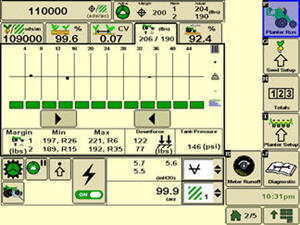 SeedStar 3 HP downforce planter run page
SeedStar 3 HP downforce planter run page
With changing field conditions, it is important to monitor down force to ensure consistent seed placement. Seeds placed too shallow or too deep can impact emergence and affect yield.
With the SeedStar 3 HP monitoring system, row-unit downforce information is measured by the downforce sensor and sensor nodes and transmitted to the GreenStar Display in the tractor cab. The row-unit downforce information is displayed on the top portion of this run page with more row-unit downforce information on the lower portion.
Active pneumatic downforce takes SeedStar 3 HP even further by removing constant downforce adjustments from the operator and actively controlling the downforce system to maintain a desired target margin. Just set the row-unit target margin value and the active pneumatic downforce system works automatically to make sure the planter maintains this value-achieving, precise soil penetration and consistent planting depth without sidewall soil compaction. This frees the operator from constantly making manual downforce adjustments as conditions change.

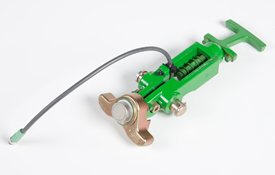
Depending on the planter size, different configurations of sensor nodes and downforce sensors are installed in support of the SeedStar 3 HP monitoring system.
SeedStar 3 HP is only available with the MaxEmerge 5e and ExactEmerge row-unit compatible planters built prior to model year 2018. Performance upgrade kits, DR models, and custom-built planters will continue to use SeedStar 3 HP in model year 2018.
SeedStar 3 HP ride quality and ground contact run page
 SeedStar 3 HP ride quality and ground contact run page
SeedStar 3 HP ride quality and ground contact run page
The fifth tab from the left in SeedStar 3 HP is a shared tab between ground contact and ride quality. Operators may change between the two criteria based on their planter setups or personal preferences. Ground contact displays the percentage of time the row-units are engaging the ground, the load is measured via a sensor through the gauge wheels. Ground contact is recommended when using ExactEmerge™ row-units to ensure the row-unit is maintaining proper depth at higher planting speeds.
SeedStar 3 HP seed spacing monitoring
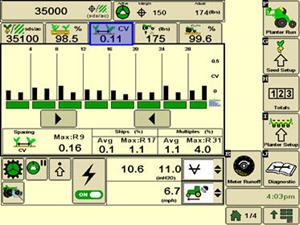 SeedStar 3 HP seed spacing planter run page
SeedStar 3 HP seed spacing planter run page
Throughout the planting process, obtaining good seed spacing is critical towards achieving plant growing conditions for maximum yield potential.
Today, many items are adjusted on the planter prior to planting to optimize overall seed spacing performance. But after such adjustments are made, information about the actual seed spacing performance during planting was missing within the planter monitoring system. With SeedStar 3 HP, seed spacing information is transmitted live via the GreenStar Display to show the operator exactly what is happening with the planter behind them.
The SeedStar 3 HP transmits seed spacing information onto the bar graph (shown to the left) for easy understanding of planter seed spacing performance. Also, information about seed skips and multiples are provided to help understand actual planter meter performance and other related system functions in order to make necessary adjustments if needed.
SeedStar 3 HP meter runoff page
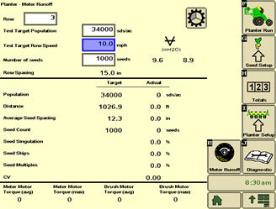 SeedStar 3 HP runoff page
SeedStar 3 HP runoff page
On SeedStar 3 HP, the meter runoff page allows growers to test meters before going to the field. Growers can now test the meters without removing them and have confidence in their planter’s performance before going to the field. Many parameters are able to be viewed during this test such as: singulation, seed count, skips, multiples, coefficient of variation (cv), etc. This test assures that the meter is in healthy condition and ready to plant when conditions are appropriate.
Other SeedStar 3 HP monitoring features include:
- Capable of monitoring individual row-unit and overall planter performance in terms of seed spacing, singulation, and row-unit downforce
- On-screen indication of sensor node/down force sensor assemblies once configured within the monitor settings application
- Full-color display icons for easy recognition and overall aesthetics
- Pneumatic downforce system controls with the GreenStar Display application
- A run page that allows operator to view relative population levels of all rows on one screen
- Mapping of actual and target seed rates can be mapped in APEX™ software
- Reprogrammable utilizing controller area network (CAN) via Service ADVISOR™ diagnostics system or Service ADVISOR Remote with JDLink™ subscription
- User-configurable high fertilizer pressure alarm that allows the operator to be warned when fertilizer pressure reaches a specific level
- Automatic Fast Start for SeedStar 3 HP. This ensures that seeds will be place accurately when starting from a stop.
- Automatic tractor speed source selection. When equipped with an 8000/9000 Series Tractor, the system selects the radar speed or allows for manual speed input selection.
Components and operation
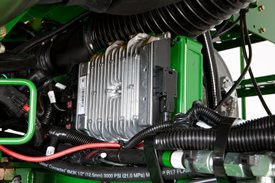 Planter main controller
Planter main controller
 Row-unit controller (RUC) with two electric motors
Row-unit controller (RUC) with two electric motors
The SeedStar 3 HP monitoring system contains the following components in order to support the planting data transfer to the GS Displays:
- Planter main controller
- Sensor node(s)
- Downforce sensor assembly
- Electric power gen controller
- Electric power gen (EPG)
- Row-unit controller (RUC)
The row-unit controller processes the row-unit data from the sensor node assemblies located on the row-unit head casting. The processed information is then sent to the planter main controller to be integrated into the displayed information being sent to the GreenStar Display.
Downforce sensor assemblies are found on row-units with sensor nodes installed. The downforce sensor assembly is put together with the gauge wheel depth-adjustment handle and provides gauge wheel pressure information to the respective sensor node for data processing.
SeedStar™ XP monitoring system
SeedStar XP overview
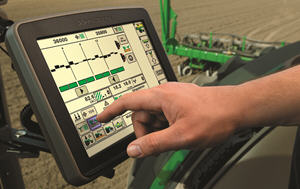 SeedStar XP shown on the GreenStar™ 3 2630 Display
SeedStar XP shown on the GreenStar™ 3 2630 Display
 SeedStar XP shown on the GreenStar 2 1800 Display
SeedStar XP shown on the GreenStar 2 1800 Display
Building upon the foundation of SeedStar 2, the SeedStar XP system takes planter monitoring to the next level. SeedStar XP is compatible with the GreenStar 2 1800 and 2600 Displays, GreenStar 3 2630 Display, the Gen 4 4200 CommandCenter™ Display, the Gen 4 4600 CommandCenter Display, the 4240 Universal Display, and the 4640 Universal Display. SeedStar XP is not compatible with the Gen 4 Extended Monitor.
Specific information about how the planter is performing enables the operator to make needed adjustments for implement optimization.
The SeedStar XP planting functions are fully integrated with the full spectrum of Precision Ag Technology applications such as Swath Control Pro™ system for planters, GreenStar AutoTrac™ assisted steering system, John Deere Operations Center, Documentation, and others. Integrated planting technologies for better asset utilization and ease of use is just part of what SeedStar XP provides.
SeedStar XP seed singulation monitoring
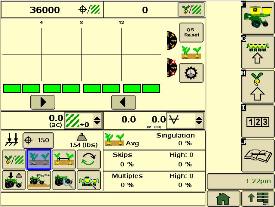 SeedStar XP seed singulation planter run page
SeedStar XP seed singulation planter run page
Understanding the meter singulation performance on the planter is critical to minimizing the amount of seed multiples and skips. As a result, the SeedStar XP monitoring system provides real-time information from the row-units about the overall seed singulation performance.
As seen in the screen shot image above, seed multiple information is displayed on the top portion of the planter-at-a-glance bar with seed skip information on the lower portion. This provides the operator a better understanding of relative seed multiple and skip data on a row-unit basis, all within one easy glance.
Also, within the seed singulation planter run page, information about row-units with the highest percentage of seed multiples and skips is provided in order to make necessary adjustments for better planter optimization.
SeedStar XP row-unit ride dynamics planter run page
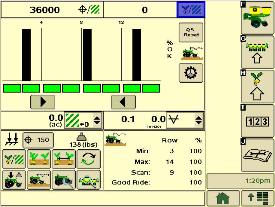 SeedStar XP ride dynamics planter run page
SeedStar XP ride dynamics planter run page
While operating a planter, travel speed and field conditions can affect the amount of row-unit bounce that is experienced. Excessive row-unit bounce or vertical motion can cause problems with meter performance. To better understand the amount of row-unit vertical motion when travelling through a field, the SeedStar XP monitoring system provides real-time information on row-unit ride dynamics.
As seen in the ride dynamics planter-at-a-glance screen shot image above, the SeedStar XP system provides ride dynamic information for each sensor node that is mounted on the planter. Each sensor node transmits ride dynamic information for each planter frame section to allow for the operator to make necessary operating adjustments to improve overall planting performance.
SeedStar XP row-unit downforce planter run page
 SeedStar XP downforce planter run page
SeedStar XP downforce planter run page
As row-unit downforce systems gradually change from heavy-duty downforce springs to pneumatic downforce, being able to understand the amount of as-applied row-unit downforce is needed while operating the planter.
With various soil conditions, moisture, etc. experienced while planting, it is imperative to have the ability to change actual row-unit downforce to have enough force for the Tru-Vee openers to penetrate the soil media. However, in some conditions, having too much downforce applied to the row-units for effective opener penetration could cause problems with side wall compaction from the gauge wheel.
Side wall compaction within the seed furrow can cause hatchet roots to develop, or roots that do not have the ability to penetrate the seed furrow soil media. This could lead to poor plant emergence and eventually lower overall yield performance.
With the SeedStar XP monitoring system, row-unit downforce information is measured by the downforce sensor and sensor nodes and transmitted to the GreenStar 2 Display in the tractor cab (as seen in the image above). The row-unit downforce information is displayed on the top portion of the planter-at-a-glance bar with more row-unit downforce information on the lower portion.
Two different control options are available on 1775NT, 1795, and DB Series Planters for pneumatic downforce. The base pneumatic downforce system requires manual control of the downforce to maintain the desired planting results or row-unit margin. Optional active pneumatic downforce takes SeedStar XP even further by removing constant downforce adjustments from the operator and actively controlling the downforce system to maintain a desired target margin.
SeedStar XP seed spacing monitoring
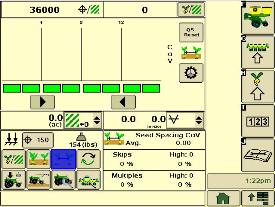 SeedStar XP seed spacing planter run page
SeedStar XP seed spacing planter run page
Throughout the planting process, obtaining good seed spacing is critical toward achieving plant growing conditions for maximum yield potential.
Today, many items are adjusted on the planter prior to planting to optimize overall seed spacing performance. After such adjustments are made, information about the actual seed spacing performance during planting was missing within the planter monitoring system. Now with SeedStar XP, seed spacing information is transmitted live via the GreenStar display to show the operator exactly what is happening with the planter behind them.
The SeedStar XP transmits seed spacing information onto the planter-at-a-glance bar for easy understanding of planter seed spacing performance. Also, information about seed skips and multiples is provided to help understand actual planter meter performance and other related system functions in order to make necessary adjustments if needed.
NOTE: Seed spacing and seed singulation information is only available when planting crops with seed drop rates below 40 seeds per second such as corn. With higher population crops such as soybeans the system does not provide spacing and singulation information because the number of seeds dropping per second is much higher.
SeedStar XP full planter performance page
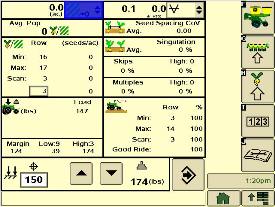 SeedStar XP planter details
SeedStar XP planter details
With the capability of monitoring differences in planting performance items such as seed singulation and row-unit downforce, having one screen to view all planter performance elements is needed to understand the whole planting system. SeedStar XP combines all of the various planting performance elements into one full-color, planter overview screen to enable for a quick understanding of relative planting functionality.
SeedStar XP half screens and other features
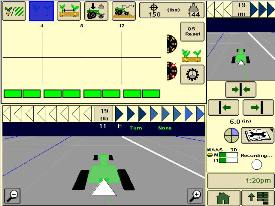 SeedStar XP seed singulation half screen
SeedStar XP seed singulation half screen
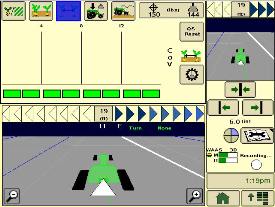 SeedStar XP seed spacing half screen
SeedStar XP seed spacing half screen
Other SeedStar XP monitoring features include:
- Capable of monitoring individual row-unit and overall planter performance in terms of seed spacing, singulation, and row-unit downforce
- Split-screen applications to enable use of popular guidance features such as AutoTrac assisted steering system
- On-screen indication of sensor node/downforce sensor assemblies once configured within the monitor settings application
- Full-color display icons for easy recognition and overall aesthetics
- Pneumatic downforce system controls with the GS display application
SeedStar 2 monitoring original features
SeedStar XP retains all of those SeedStar 2 features that producers value and have come to expect:
-
Planter-at-a-glance – allows operator to view relative population levels of all rows on one screen.
-
Automatic valve calibration – with the SeedStar variable-rate drive (VRD), this is now completed automatically. There is no longer a need to manually calibrate the hydraulic valves.
-
Increased population updates – SeedStar will now update population levels once per second at planter start up then approximately once every three seconds.
-
Mapping of actual seed rates – when combined with documentation, actual and target seeding rates can now be mapped in John Deere Operations Center.
-
Reprogrammable utilizing controller area network (CAN) via Service ADVISOR™ diagnostics system.
-
Improved diagnostics/event recorder – on SeedStar VRD planters, additional diagnostic information is available, as well as an event recorder to capture system performance data at a specific point in time.
-
Ability to run motors at different population levels – on SeedStar VRD, operators running multiple motor systems can run each motor at a different speed, allowing different population levels within a planter.
-
User-configurable high fertilizer pressure alarm – allows the operator to be warned when fertilizer pressure reaches a specific level.
-
Automatic quick-start for SeedStar VRD – no longer does the operator need to press the quick-start button on end row turns to resume planting.
-
Automatic tractor speed source selection – when equipped with an 8000/9000 Series Tractor, the system selects the radar speed or allows for manual speed input selection.
Components and operation
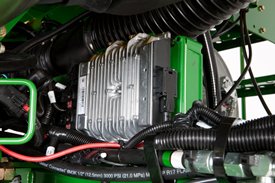 Planter main 2 controller
Planter main 2 controller
 Sensor node assembly installed
Sensor node assembly installed
The SeedStar XP monitoring system contains the following components in order to support the planting data transfer to the GreenStar 2 Displays:
- Seed monitor/variable-rate (SMVR) controller with model year 2011 or newer software
- Planter main 2 controller (installed on all SeedStar XP eligible models for model year 2011 or newer)
- Sensor node(s)
- Downforce sensor assembly
The planter main 2 controller processes the row-unit data from the sensor node assemblies located on the row-unit head casting. The processed information is then sent to the SMVR controller to be integrated into the displayed information being sent to the GreenStar Display.
Downforce sensor assemblies are found on row-units with sensor nodes installed. The downforce sensor assembly is assembled with the gauge wheel depth-adjustment handle and provides gauge wheel pressure information to the respective sensor node for data processing.
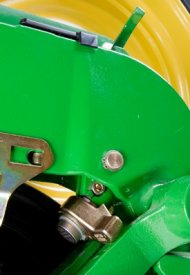 Downforce sensor installed
Downforce sensor installed
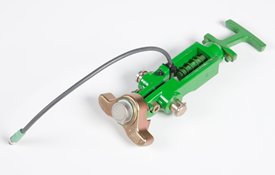 Downforce sensor assembly
Downforce sensor assembly
Depending on the planter size, different configurations of sensor nodes and downforce sensors are installed in support of the SeedStar XP monitoring system.
Increase job performance when planting and spraying
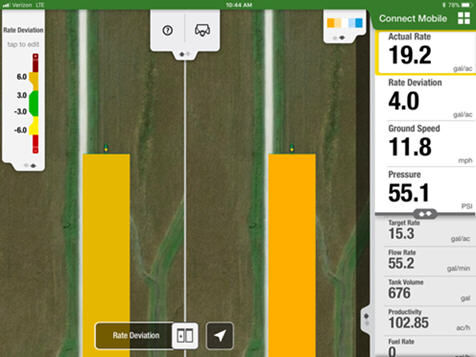 Connect Mobile comparison map lets users compare two quality layers at once for planting and spraying
Connect Mobile comparison map lets users compare two quality layers at once for planting and spraying
Connect Mobile overview
John Deere Connect Mobile is a solution that utilizes an Apple® iPad® tablet in the cab and helps the operator increase job performance during planting and spraying operations. Connect Mobile documents and displays multiple quality layers, helping the operator monitor and more easily detect problems that can occur during planting and spraying. Connect Mobile also has a common user interface that makes it easy to use between different pieces of John Deere equipment.
Planting attributes
Monitor and document key performance indicators in high-definition map layers and dashboard tiles such as:
- Actual population
- Target population
- Singulation
- Seed-spacing CV
- Applied downforce
- Gauge wheel margin
- Ride quality
- Ground speed
- Variety
Spraying attributes
- Actual rate
- Rate deviation
- Ground speed
- Pressure
In base equipment
Planting
Connect Mobile hardware is factory installed on all model year 2015 and newer planters factory installed with ExactEmerge™ row-units and all model year 2017 and newer planters factory installed with MaxEmerge™ 5e row-units, making it easy to get started with Connect Mobile.
Spraying
Connect Mobile hardware is factory installed on all model year 2018 Sprayers with the 4600 CommandCenter™ display. Producers can also retrofit Connect Mobile on older sprayers with a GreenStar™ 3 2630 Display by installing the sprayer field kit.
Learn more about Connect Mobile in the Field and Crop Solutions section within the Precision Ag Technology product line and how it can improve the quality of a planting and spraying job.
iPad and Apple are trademarks of Apple Inc.
Steerable axles
For increased maneuverability into narrow driveways and field approaches, the steerable axle is an option on all DB80, DB88, DB90, and DB120 models. The steerable transport axle still utilizes a pivoting rockshaft with dual lifting cylinders and combines a single steering cylinder with dual linkage assemblies. With the linked pivot points close to the centerline of each wheel, it allows a shorter cylinder stroke and smaller turn angles to translate into a tighter implement turn radius. The same 445/50R22.5 wheels are used with the steerable axle option.
The option will require an extra selective control valve (SCV), independent of all other implement functions. The option code will provide a full manually functioning axle assembly with an included in-cab display for calibrating and reading wheel angle position. The steerable axle package can be used for manual road transport functions around intersections and tight field entrances.
If desired, steerable axles can be combined with John Deere Active Implement Guidance (iSteer™ guidance and machine control system) to provide automatic planter guidance for in-field applications. The following additional components must be purchased separately from John Deere for the steerable axle to compliment Active Implement Guidance.
Components:
- iSteer tractor application controller (with activation)
- iSteer tractor harness
- StarFire™ receiver for planter
All required implement harnessing will be included in the option code. This includes the StarFire receiver harness. The receiver mast will also be provided when the option code is selected.
The purchase, installation, and calibration of the iSteer components are the responsibility of the dealership at time of predelivery.
Features
Finger joints
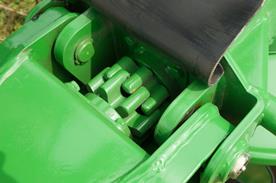 Finger joint
Finger joint
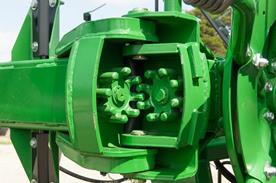 Folded finger joint
Folded finger joint
These joints reduce the number of moving parts and wear points to provide a more direct transition of power for longer life and improved performance. When the hinge is folded up, the fingers are still in contact to maintain proper alignment; then, when the fingers fold down, they lock into place.
The finger joints are supported by sealed bearings to reduce wear and vibration. This results in longer machine life, reduced downtime, and a more consistent delivery of torque to the outer rotors.
Hydraulic tine pitch control
 Hydraulic tine pitch control on the TD3427
Hydraulic tine pitch control on the TD3427
 Hydraulic tine pitch control on the TD3418
Hydraulic tine pitch control on the TD3418
The tine pitch height can be adjusted hydraulically inside the cab using the handle on the tedder, so the operator never needs to leave the seat once the tine pitch height has been set. This allows for quick customization to mowed hay height in different fields, as well as on-the-go compensation for terrain changes such as terraces.
Hands-free locking transport wheels
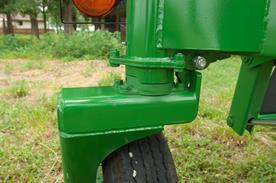 Hands-free locking transport wheels
Hands-free locking transport wheels
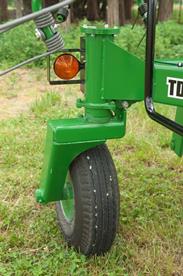 Hands-free locking transport wheel overall
Hands-free locking transport wheel overall
The TD3427 Tedder is equipped with a cart that the rotors fold onto for field-to-field transport. On the cart are larger transport wheels to provide greater stability when traveling down the road. These wheels come with a hands-free locking mechanism that automatically locks the wheels in a straight, forward position when the rotors are folded in the transport position.
When the transport tires are locked in a straight position, it allows for substantially easier backing up of the machine and provides greater stability when traveling down the road at higher speeds.
Transport wheel suspension
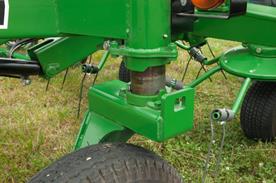 Transport wheel suspension
Transport wheel suspension

The transport wheels on the TD3427 come equipped with a spring suspension system inside the housing which forces the cart to be raised once the weight of the rotors are removed during unfolding. The additional clearance created by this suspension system helps the tedder float over small surface changes.
Over-center folding
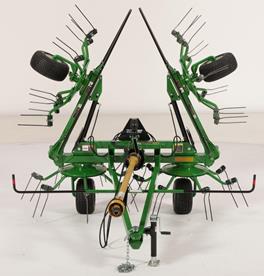 Over-center folding
Over-center folding

The TD3418 features an over-center hydraulic folding design, so when changing from operating to transport position there is no need to leave the tractor seat.
Features
Digidrive® drive system ensures maximum life
 Digidrive system
Digidrive system

The exclusive Digidrive rotor drive fingers on the TD13 Series Hay Tedder are made from forged, case-hardened, heat-treated steel for maximum life and smooth power transmission.
Digidrive is a U.S.- registered trademark of Kuhn S.A. Joint Stock Company, France
Durable steel tines resist fatigue
 Flexible steel for durability and dependability
Flexible steel for durability and dependability
The TD13 Series Hay Tedder has flexible, steel tines that are heat treated for durability and highly resistant to fatigue.
Rotor adjustment
 Hydraulic angle adjustment for easy transport
Hydraulic angle adjustment for easy transport

The Frontier™ TD13 Series Hay Tedder comes standard with hydraulic angle adjustment, perfect for transporting the tedder to multiple fields.
It allows the operator to set the working angle of the tedder one time and then quickly and easily go from the transport to the working position, using the tractor hydraulics from the comfort of the seat.
Balloon tires operate smoothly, even over bumpy ground
 Balloon-technology tires on Frontier&tm; TD13 Series
Balloon-technology tires on Frontier&tm; TD13 Series
The TD13 Series Hay Tedder's large balloon tires allow smoother operation over irregular ground.
Features
Compact design for optimal transport dimensions
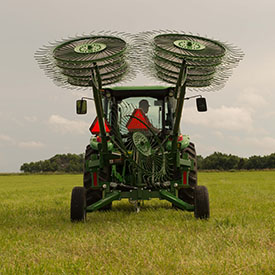 Wheel rake arms in transport position
Wheel rake arms in transport position
The raking arms and wheels fold on the cart for a minimum transport width of 2.5 m (8.2 ft). This compact design allows an operator to easily transport and store the equipment.
Hydraulic lock out valves and wing transport chains keep the wings safely folded up during transport.
Carted design with wide wheel base and high ground clearance
 Greater ground contact with wide wheel base
Greater ground contact with wide wheel base
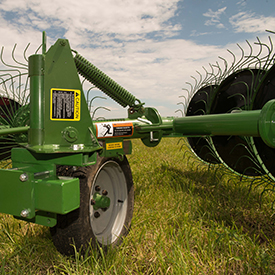 Sturdy frame and high ground clearance
Sturdy frame and high ground clearance
The 1.8-m (6-ft) wheel width helps keep the raking wheels in contact with the ground over rough terrain, increasing productivity. The wheel rake has 50.8 cm (20 in.) of ground clearance which helps keep the hay away from the cart frame.
Increased wear life of moving components
 One grease zerk per wheel
One grease zerk per wheel
The wheels have 7-mm (0.28-in.) diameter tines for increased wear life. The larger-sized tines will stand up to more crop and ground movement during use.
Grease zerks also help increase the wear life of each wheel. There is one grease zerk for each wheel and two grease zerks located on the frame to keep moving parts lubricated and operative.
Quick field adjustments
 Easy-to-set windrow and raking widths
Easy-to-set windrow and raking widths
 Three settings for dual-spring rake arm suspension
Three settings for dual-spring rake arm suspension
The WR00 Series Carted Wheel Rake has two easy adjustment points to fine-tune windrows and gather more hay in each bale.
- Utilize the two-point-position pin and hole adjustment to set both windrow and raking widths.
- Set the adjustable dual-spring rake arm suspension to three different settings to match terrain and crop conditions.
Adjustable hitch to match wide array of tractor drawbar heights
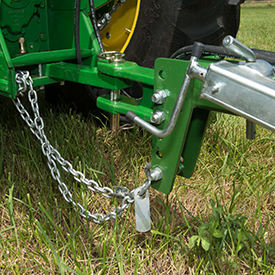 Simple hitch adjustments for different heights
Simple hitch adjustments for different heights
The adjustable hitch allows for added versatility for the WR00 Series Wheel Rake. The wide array of tractor tire sizes, drawbar heights, and hitch adjustments add more convenience for hay operations.
Features
Rake adjustments are easy
 Hydraulics allow adjustments from tractor seat
Hydraulics allow adjustments from tractor seat
 Adjust pitch of rake tines with hand crank
Adjust pitch of rake tines with hand crank
Hydraulically raise and lower the RR23 Series Rotary Rake without leaving the tractor seat.
Easily adjust the pitch of the rake tines with the hand crank.
Rugged 13-arm rotor with adjustable cam
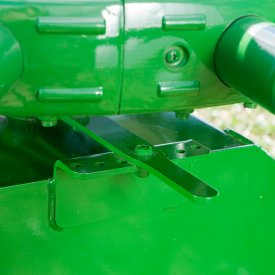 Adjustments are easy
Adjustments are easy

The RR23 Series Rotary Rakes have rugged 13-arm rotors featuring an adjustable cam.
This allows the operator to change the aggressiveness of the tines to the crop conditions – more aggressive for wet crops and less aggressive for delicate crops like alfalfa.
Tandem flotation tires, dual gauge wheels, and tandem walking beam axle
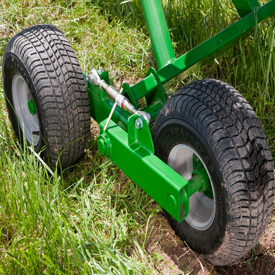 Flotation tires provide top-quality performance
Flotation tires provide top-quality performance
 Dual gauge wheels standard on RR2324
Dual gauge wheels standard on RR2324
Four large tandem flotation tires on the RR2313 Rotary Rake and eight large tandem flotation tires on the RR2324 Rotary Rake provide maximum durability when operating over rough terrain.
Tandem walking beam axles on both RR23 Series Rotary Rakes provide a smooth ride over rough terrain and follow ground contours, allowing for proper crop pickup.
Additional flotation tires (two per rotor) are available on the RR2324 for even greater ground contour following.
Dual gauge wheels located on the front of the rear basket of the RR2324 are standard. The dual gauge wheels maintain a constant height of the tines, helping follow ground contours on rolling terrain.
Hydraulically adjustable swath curtain for rear rotor
 Quickly and easily adjust rear swath curtain
Quickly and easily adjust rear swath curtain

The hydraulically adjustable swath curtain is standard on the rear rotor of the RR2324 Rotary Rake.
It easily adjusts for proper windrow formation in varying crop conditions.
Cam-action tine arms
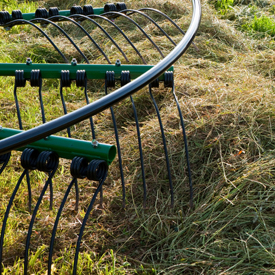 Cam-action tine arms for efficient drying time
Cam-action tine arms for efficient drying time

The cam-action tine arms on the RR23 Series Rotary Rakes gently deposit the material in the windrow, saving valuable leaves.
Furthermore, the cam action forms a higher, fluffier, faster-drying windrow that saves drying time.
The tine arms are removable to allow for narrow transport widths and more compact storage.
Adjustable swath curtain
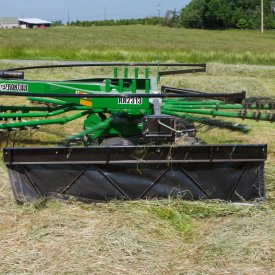 Swath curtain controls windrow formation
Swath curtain controls windrow formation
 Adjustable to accommodate raking needs
Adjustable to accommodate raking needs
The Frontier™ RR23 Series Rotary Rake swath curtain controls the windrow formation in varying crops. It can be adjusted in or out to accommodate individual harvesting needs.
When combining multiple windrows with the RR2324, the curtain can either be removed or turned upside down to prevent interfering with the hay.
Two rotors rake one large or two smaller windrows in a single pass
 Single windrow
Single windrow
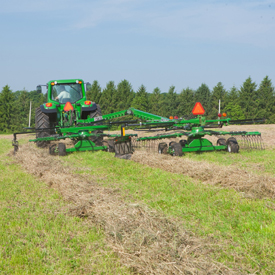 Dual windrow
Dual windrow
The RR2324 Rotary Rake is more versatile because it has two rotors, allowing it to rake one large windrow or two smaller windrows in a single pass.
Features
Cam-action tine arms
 Cam-action tine arms for efficient drying time
Cam-action tine arms for efficient drying time

The cam-action tine arms on the Frontier RR2211 Rotary Rake gently deposit the material in the swath, saving valuable leaves. Furthermore, the cam action forms a higher, fluffier, faster-drying windrow that saves drying time.
The tine arms are removable to allow for narrow transport widths and more compact storage.
Heavy-duty curtain
 Adjustable to accommodate raking needs
Adjustable to accommodate raking needs

The Frontier™ RR2211 Rotary Rake's heavy-duty vinyl curtain controls the windrow width and can be adjusted in or out to accommodate individual harvesting needs.
When combining multiple windrows, the curtain can either be removed or turned upside down to prevent interfering with the hay.
Hydraulic rake adjustments
 Hydraulics create ease for the operator
Hydraulics create ease for the operator

Hydraulically adjust the Frontier™ RR2211 Rotary Rake's height and pitch without leaving the tractor seat.
Both functions are controlled with one simple hydraulic circuit.
Tandem flotation tires
 Flotation tires provide top-quality performance
Flotation tires provide top-quality performance
Four large tandem flotation tires on the Frontier™ RR2211 Rotary Rake provide maximum durability when operating over rough terrain.
Features
Cam-action tine arms
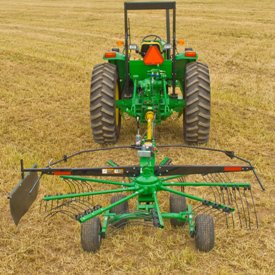 Cam-action tine arms reduce drying time
Cam-action tine arms reduce drying time

The cam-action tine arms on the RR2109 Rotary Rake gently deposit the material in the swath, saving valuable leaves.
Furthermore, the cam action forms a higher, fluffier, faster-drying windrow that saves drying time.
Heavy-duty curtain
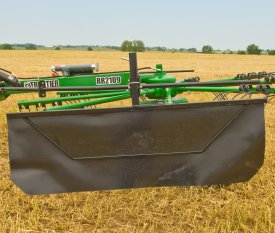 Adjustable to accommodate raking needs
Adjustable to accommodate raking needs

The Frontier™ RR2109 Rotary Rakes' heavy-duty vinyl curtain controls the windrow width and can be adjusted in or out to accommodate individual harvesting needs.
When combining multiple windrows, the curtain can either be removed or turned upside down to prevent interfering with the hay.
Hydraulic rake adjustments
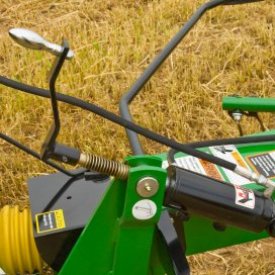 Hydraulics create ease for the operator
Hydraulics create ease for the operator

Hydraulically adjust the Frontier™ RR2109 Rotary Rake height and pitch without leaving the tractor seat.
Both functions are controlled with one simple hydraulic circuit.
Tandem flotation tires
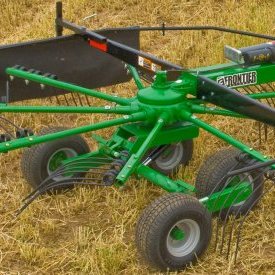 Flotation tires provide top-quality performance
Flotation tires provide top-quality performance

Large tandem flotation tires on the Frontier™ RR2109 Rotary Rake provides maximum durability when operating over rough terrain.
Features
High-capacity design
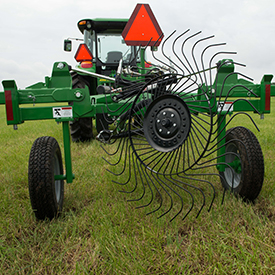 High frame clearance increases productivity
High frame clearance increases productivity
The WR31 Series High-Capacity Carted Wheel Rake has a high frame clearance and an increased distance between the transport wheels and raking wheels, measured at 81.3 cm (32 in.) and 45.7 cm (18 in.) respectively. This clearance allows for a high volume of crop to flow through the rake, reducing crop plugging while increasing productivity.
Large raking wheels for added productivity
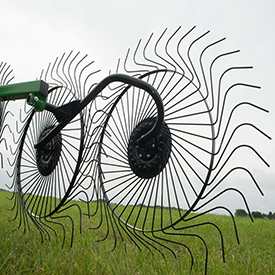 High-quality hay with larger raking wheels
High-quality hay with larger raking wheels
The 152.4-cm (60-in.) diameter raking wheels of the WR31 Series have fewer revolutions per hour than a smaller raking wheel traveling at the same ground speed. This reduction in revolutions minimizes crop leaf loss, leading operators to produce higher quality hay. A larger diameter wheel will have a longer wear life, increasing the life of the raking tines.
Quick field adjustments
The WR31 Series High-Capacity Carted Wheel Rake has three easy adjustment points to fine-tune windrows and gather more hay in each bale.
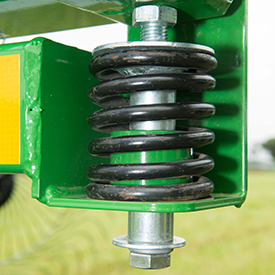 Adjustable down-pressure spring
Adjustable down-pressure spring
1. Simply change down pressure by adjusting a spring to the desired setting for accuracy on uneven terrain.
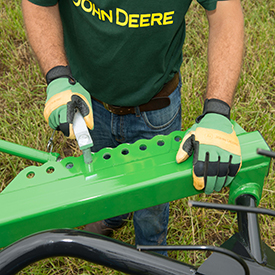 Increase crop volume by adjusting simple adjustment
Increase crop volume by adjusting simple adjustment
2. Adjust wheel rake width to gather higher volumes of crop by adjusting a single pin and clip.
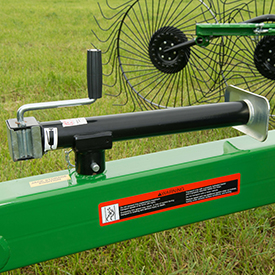 Windrow jack for quick and easy adjustments
Windrow jack for quick and easy adjustments
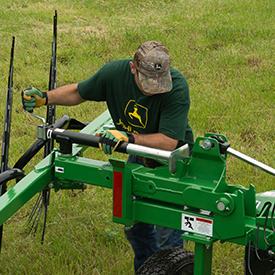 Adjusting windrow width
Adjusting windrow width
3. Fine-tune the windrow width by utilizing the jack to adjust the pitch of the wheel rake beams to get the right size windrow for the baler. (Only available on the WR3110 and WR3112 models)
Kwik Pik wheel system
 Rake arms in position with Kwik Pik system
Rake arms in position with Kwik Pik system
 Kwik Pik system mechanism
Kwik Pik system mechanism
The Kwik Pik system lifts both rake arms at the same time. This system allows for immediate clearance of the rake wheels from the crop, which in turn does not affect the windrow form during headland turns. Headland turns can be made faster, increasing productivity and uptime for the operator. The windrows will maintain a rectangular shape for easy pickup with a baler.
Adjustable hitch to match wide array of tractor bar heights
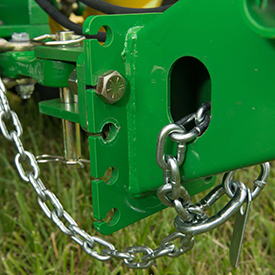 Convenient and quick hitch adjustments
Convenient and quick hitch adjustments
The adjustable hitch allows for added versatility with the WR31 Series High-Capacity Carted Wheel Rake. With the wide array of tractor tire sizes and drawbar heights, hitch adjustments add more convenience for large hay operations.
Single tractor selective control valve (SCV) with double-acting valve
 Double features increase pressure and cycle time
Double features increase pressure and cycle time
The double-acting valve allows hydraulic pressure to flow both in and out, providing a 25 percent faster hydraulic cycle time.
Individual wheel hub grease zerks
 Easy maintenance with accessible grease zerks
Easy maintenance with accessible grease zerks
The ability to properly lubricate moving parts, such as the wheel, extends the life of these parts, leading to increased uptime.
Center kicker wheel conversion kit for carted wheel rakes
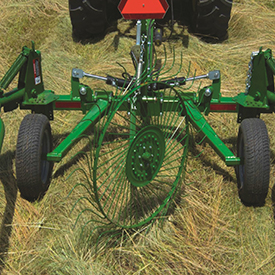 Option featured on WR00
Option featured on WR00
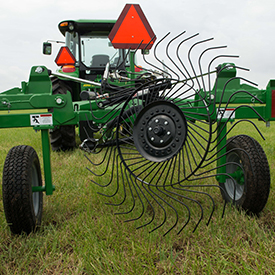 Option featured on WR31
Option featured on WR31
The center kicker wheel conversion kit improves drying time and windrow pickup for the baler by raking the hay in the center of the rake that is not turned by the rake wheels.
Wind panel conversion kits for WR10, WR20E, WR21, WR22, WR23, WR31, WR41, WR43, and WR60 Series Wheel Rakes
When ordered as a field conversion kit, it includes one wind panel with the corresponding hardware. This is used on wheel rakes when the application is short or when raking dry crops that can blow through a standard rake wheel.
Features
Offset wheels for smooth, level raking
 Offset wheels are perfect for uneven terrain
Offset wheels are perfect for uneven terrain

The limited oscillating, offset tandem wheels on the Frontier™ WR12 Series High-Capacity Wheel Rake ensure a smooth ride, even over irrigation tracks.
Narrow transport width
 Creates easy transport for narrow roads
Creates easy transport for narrow roads

Frontier™ WR12 Series High-Capacity Wheel Rakes open and close hydraulically. Transport widths are 2.6 m (8.5 ft) or less, making it easy to negotiate narrow roads and gates.
Easy windrow width adjustment
 A crank aids the windrow width adjustment
A crank aids the windrow width adjustment
A crank located at the rear of the Frontier™ WR12 Series High-Capacity Wheel Rake makes it easy to adjust the windrow width.
Hydraulic aftermarket kits for wheel rakes
The first conversion kit listed consists of hydraulic couplers that are not standard equipment on WR1212, WR1214, WR1216, and WR1218 Wheel Rakes.
The second and third conversion kits allow the operator to hydraulically open and close raking arms on the featured wheel rakes instead of having to manually adjust them.
Center kicker wheel conversion kit for WR12 Wheel Rakes
The center kicker wheel conversion kits have either two or three center kicker wheels that rake the hay in the center of the WR12 Series High-Capacity Wheel Rakes. These center kicker wheels improve drying time and windrow pickup for the baler by raking the hay that is not turned by the rake wheels.
Wind panel conversion kits for WR11, WR12, WR33, and WR34 Wheel Rakes
This conversion kit includes one wind panel with hardware. It is used on wheel rakes for applications involving short or dry crops that can blow through a standard rake wheel.
Wheel conversion kits for WR12, WR23, WR23, and WR33 Wheel Rakes
The tandem wheel conversion kits for the WR12, WR22, WR23, and WR33 Series Wheel Rakes improve the ride over rough fields and terrain.
The two-wheel add-on kit converts the WR1214 to a WR1216 to increase raking width.
The extra wheels conversion kits add fifth and sixth wheels to the WR2212 and WR2316. The extra wheels support the ends of each wing to reduce raking wheels from over-engaging the ground on rough or rolling terrain.
Rake beam support wheel kit for WR1214 and WR1216 Wheel Rakes
 Rake beam support wheel
Rake beam support wheel

Rake beam support wheels provide added support to the front corner of each beam of the wheel rake. They improve float over irrigation tracks, as well as in rough ground conditions.
NOTE: When ordering a quantity of one, two wheels are shipped, one for each side of the beam.
Features
Bale fork for handling multiple large square bales with ease
 MJ4060 holds bales for placement and stacking
MJ4060 holds bales for placement and stacking
The Frontier™ MJ4060 Bale Fork attachment can handle almost any sized large square bales with ease. It features hooks along the side that are hydraulically activated and hold bales for placement and stacking.
The MJ4060 Bale Fork is made with strong, abrasion-resistant steel. The forks resist bending and stand the test of time. The fork features single auxiliary hydraulic service and quick-attach compatibility.
Bale squeeze handles large square bales efficiently
 Holds bale tight while leaving it in good shape
Holds bale tight while leaving it in good shape
For operators who handle a lot of large square bales, the Frontier™ MJ4090 or MJ4091 Bale Squeeze will leave the bales in good shape, even after being handled several times.
Whether choosing the 121.9-cm or 279.4-cm (48-in. or 110-in.) width, each Frontier bale squeeze features two 243.8-cm (96-in.) arms that hydraulically squeeze the bale's sides, plus a power squeeze operation for clamping bales.
Choose from 907.2-kg or 1814.4-kg (2000-lb or 4000-lb) models that are suitable for machines with up to 2721.6 kg (6000 lb) of capacity. The bale squeeze models feature dual auxiliary hydraulic service and quick-attach compatibility.
Brush grapple gets the debris while leaving the dirt behind
 BG1096 for a variety of material handling
BG1096 for a variety of material handling
The Frontier™ BG1096 Brush Grapple is a great, versatile attachment for those who want to collect debris and leave dirt behind. Now operators can move logs, rocks, or debris, rake pile, or do site cleanup only without collecting dirt along the way.
The BG1096 Brush Grapple has a 0.91-m³ (1.19-cu yd) bucket with two independent top grabs. The brush grapple features single auxiliary hydraulic service and quick-attach compatibility.
Bucket and grapples for handling large bales or yards of silage
 AT1096U handles up to 4.6 m3 (6 cu yd) of silage
AT1096U handles up to 4.6 m3 (6 cu yd) of silage
 AT2016G comes standard with bolt-on cutting edge
AT2016G comes standard with bolt-on cutting edge
 AT2016U features five replaceable tines
AT2016U features five replaceable tines
Frontier™ offers three bucket grapples to handle large round bales or secure as much as 4.6 m³ (6 cu yd) of silage, depending on producer needs.
The AT1096U Bucket Grapple measures 243.8-cm (96-in.) wide with 1.2 m³ (1.6 cu yd) of bucket capacity. Features include an optional grapple with spill screen and single auxiliary hydraulic service. A bolt-on cutting edge is standard, and this model is quick-attach compatible.
The AT2016G Bucket is perfect for silage needs and comes standard with a bolt-on cutting edge. The bucket measures 243.8-cm (96-in.) wide and holds 1.2 m³ (1.6 cu yd). The AT2016G Bucket is also quick-attach compatible. A five-tine silage/round bale grapple is optional.
The AT2016U Bucket comes standard with a bolt-on cutting edge and grapple for handling silage and round bales. The AT2016U measures 243.8-cm (96-in.) wide and has 1.2 m³ (1.6 cu yd) of bucket capacity. The AT2016U features five replaceable tines and a standard spill guard, and it is quick-attach compatible.
Debris grapple for handling debris and irregular-shaped material
 MJ4062 easily clears large amounts of debris
MJ4062 easily clears large amounts of debris
The MJ4062 Debris Grapple combines the capability of a standard bucket with the ability to grab debris and irregular-shaped material with the grapples.
With a 1.7-m³ (2.25-cu yd) bucket and two independent top grabs, it is the ideal choice for the commercial operator or a large-property owner with a lot of brush to clear. The grapple has single auxiliary hydraulic service and is quick-attach compatible.
Fork carriage features a wide backstop for handling bulky items
 QC1072 is perfect for handling large, bulky items
QC1072 is perfect for handling large, bulky items
The Frontier™ QC1072 Fork Carriage is 182.9-cm (72-in.) wide and quick-attach compatible. It is designed for 106.7-cm, 121.9-cm, and 152.4-cm (42-in., 48-in., and 60-in.) long forks. It features a wider backstop to handle bulkier items such as industrial pipe.
General-purpose bucket for handling dense materials
 MJ4079 is equipped with a full skid plate
MJ4079 is equipped with a full skid plate
The Frontier™ MJ4079 General-Purpose Bucket is good for handling dense materials such as fertilizer, lime, sand, dirt, or farmyard manure and will meet growers' needs.
The MJ4079 General-Purpose Bucket comes equipped with a full skid plate to provide rigidity and added protection from abrasive concrete floors and other paved surfaces.
The MJ4079 measures 243.8-cm (96-in.) wide, with a 1.33-m³ (1.75-cu yd) bucket capacity. It has a quick-attach connection, and the bolt-on cutting edge is standard.
Large bale spike moves two round bales or one large sqaure bale with ease
 MJ4081 is ideal for handling large hay bales
MJ4081 is ideal for handling large hay bales
The Frontier™ MJ4081 Large Bale Spike helps operators move round bales quickly and up to two at a time. It features two 124.5-cm (49-in.) forged main spikes and two 30.5-cm (12-in.) tines for stabilization.
Frontier large bale spikes can handle one large square bale or two round bales with ease. It is quick-attach compatible.
Large square bale spike handles 1.2-m x 1.2-m (4-ft x 4-ft) square bales
 BF1102S picks up two large square bales
BF1102S picks up two large square bales
The Frontier™ BF1102S Large Square Bale Spear can pick up two 1.2-m x 1.2-m (4-ft x 4-ft) large square bales at once. The bale spear does not require hydraulic services.
Light material bucket for cotton seed, wood chips, silage, or corn
 MJ4059, MJ4061, and MJ4063 for light materials
MJ4059, MJ4061, and MJ4063 for light materials

The Frontier™ MJ4059, MJ4061, and MJ4063 Light Material Buckets are great for handling light materials such as cotton seed, wood chips, silage, or corn and will meet operator needs. The buckets feature wear-resistant skid bars for strength and added life.
Frontier offers three bucket sizes to choose from:
- 1.7 m³ (2.25 cu yd)
- 1.9 m³ (2.50 cu yd)
- 2.5 m³ (3.25 cu yd)
The buckets measure 243.8-cm (96-in.) wide. They are quick-attach compatible and come standard with a bolt-on cutting edge.
Manure fork and grab handles loose hay, straw, and more
 MJ4076 and MJ4077 have a reinforced mainframe
MJ4076 and MJ4077 have a reinforced mainframe
The Frontier™ MJ40 Manure Fork and Grab is available in two sizes: the MJ4076 model is 182.9-cm (72-in.) wide and the MJ4077 model is 243.8-cm (96-in.) wide. They can handle loose hay, farmyard manure, or straw and will meet any operator's needs.
The manure fork and grab has a reinforced mainframe and large-diameter, heavy-duty tines. Frontier manure fork and grab attachments resist bending as they break up compacted livestock manure and bedding. They offer single auxiliary hydraulic service and quick-attach compatibility.
Pallet forks are available in three sizes to meet application needs
 MJ1060 model is built extremely strong
MJ1060 model is built extremely strong

Frontier™ implements offers three different pallet fork options with model MJ1060 to match a grower's applications. Frontier pallet forks are drawn and forged for one-piece, homogeneous strength through the bend radius at the fork heel.
Choose from three sizes for use with all carriages:
- 106.7 cm x 10.2 cm x 4.4 cm (42 in. x 4 in. x 1.75 in.)
- 121.9 cm x 10.2 cm x 4.4 cm (48 in. x 4 in. x 1.75 in.)
- 152.4 cm x 10.2 cm x 4.4 cm (60 in. x 4 in. x 1.75 in.)
Quick-attach carriage for on the go without getting out of the cab
 MJ4058 features floating shaft fork mountings
MJ4058 features floating shaft fork mountings
There is no need to get out of the cab with the Frontier™ MJ4058 Quick-Attach Carriage. The MJ4058 is designed to attach and detach pallet forks without getting out of the cab. Carriages feature floating shaft fork mountings for easier pallet entry and exit in uneven terrain.
The MJ4058 measures 121.9-cm (48-in.) wide. Pallet forks are available in 106.7-cm, 121.9-cm, and 152.4-cm (42-in., 48-in., and 60-in.) lengths, which need to be ordered separately.
Round bale hugger moves bales up to 1.8 m (6 ft) in diameter
 MJ4099 perfectly handles silage-wrapped bales
MJ4099 perfectly handles silage-wrapped bales
The Frontier MJ4099 Round Bale Hugger is the tool for operators who need to move one bale at a time or handle silage-wrapped bales. It can handle one wrapped bale up to 1.8 m (6 ft) in diameter.
A single cylinder allows arms to hug equally. The round bale hugger has single auxiliary hydraulic service and is quick-attach compatible.
Side-shift carriage has quick-attach and side-shift pallet fork
 MJ4085 for telehandlers up to 2721.6 kg (6000 lb) of capacity
MJ4085 for telehandlers up to 2721.6 kg (6000 lb) of capacity
The Frontier™ quick-attach side-shift carriage with side-shift pallet fork gets the job done. The MJ4085 Side-Shift Carriage is built strong for telehandlers up to 2721.6 kg (6000 lb) in capacity. Side-shift carriages feature a 10.2-cm (4-in.) side, from left-to-right and single auxiliary hydraulic service.
The Frontier MJ4085 measures 121.9 cm (48 in.) wide. Pallet forks are available in 106.7-cm, 121.9-cm, and 152.4-cm (42-in., 48-in., and 60-in.) lengths, which need to be ordered separately.
Side-tilt carriage is perfect for working on uneven terrain
 MJ4084 provides safe load stabilization
MJ4084 provides safe load stabilization
The Frontier™ MJ4084 Side-Tilt Carriage is perfect for operators working on unever terrain. This quick-attach, side-tilt carriage features 10 degrees of side tilt, left or right, and a floating fork shaft. A center-pivot design and single auxiliary hydraulic service provide safe load stabilization for transport and leveling raised loads.
The MJ4084 measures 121.9-cm (48-in.) wide. Pallet forks are available in 106.7-cm, 121.9-cm, and 152.4-cm (42-in., 48-in., and 60-in.) lengths, which need to be ordered separately.
Silage bucket handles 1.9 m3 (2.5 cu yd) of silage
 MJ4118 top fingers help pull silage with ease
MJ4118 top fingers help pull silage with ease
The Frontier™ MJ4118 Silage Bucket holds 1.9 m3 (2.5 cu yd) of silage and is 243.8-cm (96-in.) wide.
The MJ4118 Silage Bucket has top fingers to help pull silage face into the bucket wtih ease. Features include an optional bolt-on cutting edge and quick-attach compatibility.
Silage defacer shaves and locks out oxygen at the same time
 SD1096 for shaving a couple of inches (mm) of silage
SD1096 for shaving a couple of inches (mm) of silage
The Frontier™ SD1096 Silage Defacer shaves off just a couple of inches (mm) of silage from the silage bunker's face for a day's feeding. It can pierce, separate, and rake silage away without cutting or reducing the size of the silage
SD1096 Silage Defacers leave the face of the silage bunker nice and smooth and locks out oxygen, preventing spoilage. The low-speed rake tines pierce and pull compacted silage without sizing material particles. They feature a 243.8-cm (96-in.) full working width and are quick-attach compatible.
Single bale spike for moving one round bale of hay with ease
 MJ4037 easily moves one round bale of hay
MJ4037 easily moves one round bale of hay
The Frontier™ MJ4037 Single Bale Spike has a forged main spike for added strength and wear capability.
With one 124.5-cm (49-in.) forged main spike and two 30.5-cm (12-in.) tines for stabilization, the MJ4037 can handle one round bale with ease. They are quick-attach compatible.
Small square bale fork handles multiple small square bales at once
 MJ4074 is perfect for handling small square bales
MJ4074 is perfect for handling small square bales
The Frontier™ MJ4074 Small Square Bale Fork can handle up to eight flat or 10 indexed small square bales at one time. Hydraulic claws grab and hold the bales for stacking.
Made with abrasion-resistant steel, the MJ4074 Bale Fork handles bales flat or on their sides. Bales are picked up in tight formation for easy handling. The bale fork has single auxiliary hydraulic service and is quick-attach compatible.
Features
Cutting teeth create better feed and less waste
 Cutting teeth
Cutting teeth

The cutting edges completely blend the silage, prevent sizing particles, and decrease spoilage by reducing the amount of oxygen that reaches the silage. This creates better feed and reduces waste.
Patent-pending tooth design strikes the perfect depth
 Cutting teeth
Cutting teeth

The depth-of-cut adjustment on the Frontier™ AG12 Series allows better mixing of the feed from top to bottom based on individual feeding requirements.
Adjustments can be made for different types of feed like high-moisture corn, haylage, or corn silage. The tooth sections are also replaceable, allowing for extended use of the entire implement.
Clean, non-obstructive framing gives see-through visibility
 Open frame design provides visibility
Open frame design provides visibility

The hydraulic motor and drive system are located inside the defacer's frame, which adds to the visibility and longevity of the Frontier™ AG12 Series.
Features
Cutting teeth create better feed and less waste
 Frontier™ AG11 cutting teeth
Frontier™ AG11 cutting teeth

The cutting edges completely blend the silage, prevent sizing particles, and decrease spoilage by reducing the amount of oxygen that reaches the silage. This creates better feed and reduces waste.
Patent-pending tooth design strikes the perfect depth
 Cutting teeth
Cutting teeth

The depth-of-cut adjustment allows better mixing of the feed from top to bottom based on individual feeding requirements.
Adjustments can be made for different types of feed like high-moisture corn, haylage, or corn silage. The tooth sections are also replaceable, allowing for extended use of the entire implement.
Clean, non-obstructive framing gives see-through visibility
 Open frame provides visibility
Open frame provides visibility

The hydraulic motor and drive system are located inside the defacer's frame, which adds to the visibility and longevity of the Frontier™ AG11 Series.
Features
Cutting teeth create better feed and less waste
 Cutting teeth
Cutting teeth

The cutting edges on the Frontier™ AG10 Series completely blend the silage, prevent sizing particles, and decrease spoilage by reducing the amount of oxygen that reaches the silage. This creates better feed and reduces waste.
Quick and easy attaching system
 Quick-change attaching for 600 and 700 Series
Quick-change attaching for 600 and 700 Series
 Quick-attach system for 800 Series Loaders
Quick-attach system for 800 Series Loaders
 Global attachment fits all loader series
Global attachment fits all loader series
The attaching systems are designed to allow fast, easy removal and mounting of attachments without tools. The proper attachments are as follows:
-
AG10D - 600 and 700 Series Loaders
-
AG10A - 800 Series Loaders
-
AG10G - fits all loader series
Patent-pending tooth design strikes the perfect depth
 Adjust to the best cut depth for the job
Adjust to the best cut depth for the job

The depth-of-cut adjustment allows the feed to be mixed better from top to bottom based on individual feeding requirements. Adjustments can be made for different types of feed like high-moisture corn, haylage, or corn silage.
The tooth sections are also replaceable, allowing for extended use of the entire implement.
Clean, non-obstructive framing gives see-through visibility
 Open frame increases visibility
Open frame increases visibility

The hydraulic motor and drive system are located inside the defacer's frame, which adds to the visibility and longevity of the Frontier™ AG10 Series.
Features
Quick, easy connection
 Loader connection
Loader connection
 Quick hydraulic connection
Quick hydraulic connection

A global Category 2 compatible connection enables the operator to connect by simply lining up the loader carrier to the frame, locking it into position, and connecting the quick-connect hydraulics.
Two-bale capacity
 Two-bale capacity
Two-bale capacity

By opening to 279.4 cm (110 in.), the AB17K is capable of loading trailers efficiently by stacking two bales at a time.
Maintain crop quality
 AB17K bale squeeze
AB17K bale squeeze

The AB17K is ideal for plastic-wrapped bales. By not puncturing the wrap, crop quality remains high during bale storage.
Features
Single cylinder for an even, secure bale hug
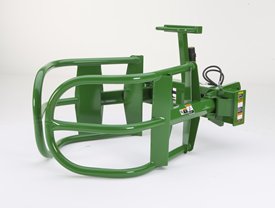 Single cylinder on the Frontier™ AH11 Series
Single cylinder on the Frontier™ AH11 Series

The AH11 Series is complete with a single cylinder, which allows the arms to hug equally around the bale.
Hitch capabilities create a super-quick connection
 Round bale hugger global hitch
Round bale hugger global hitch

These round bale huggers are equipped with attaching systems that allow the operator to make a quick and easy connection. The global hitch is compatible with all loader series.
Features
Adjustable guide bar adjusts to different bale sizes
 Guide bar adds extra protection for bales
Guide bar adds extra protection for bales

The adjustable guide bar on the Frontier™ AB16 Series makes adjusting for different bale sizes easy. All forks have greaseable bushings.
Quick, easy attaching systems
 Quick-change for 600 and 700 Series Loaders
Quick-change for 600 and 700 Series Loaders
 Quick-attach for 800 Series Loaders
Quick-attach for 800 Series Loaders
Attaching the Frontier™ AB16 Series Bale Handler to a John Deere loader is easy with the quick-change and quick-attach systems. Just line up the loader's connecting point to the attachment frame, lock in place, and go.
These hitch systems ensure an easy, efficient hookup and save time and money.
Ease of loading and handling of bales
 AB16 Square Bale Handler stacking bales
AB16 Square Bale Handler stacking bales
 Engaging teeth create easy bale pickup
Engaging teeth create easy bale pickup
The Frontier™ AB16 Series Square Bale Handler has 32 engaging teeth that hold the bales in place when handling them in the field or stacking them on a truck.
Features
Structural, tubular frame holds up to 907.2 kg (2000 lb)
 Rugged structural frame on BU10 Series
Rugged structural frame on BU10 Series

The Frontier™ BU10 Series Bale Unroller has strong, tubular framing with heavy-duty welding, which provides exceptional strength and durability.
This rugged machine can handle round bales up to 907.2 kg (2000 lb) and 1.2-m to 1.5-m (4-ft to 5-ft) wide bales up to 1.8 m (6 ft) in diameter.
Hitch connects quickly and easily and is iMatch™ and quick-hitch compatible
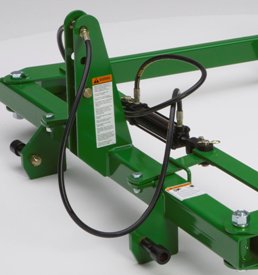 BU10 Series Bale Unroller hitch
BU10 Series Bale Unroller hitch

The BU10 Series Bale Unroller is iMatch and quick-hitch compatible with Category 1 and 2 hitches. These quick-attach systems allow for a super quick connection.
Easy hydraulic operation creates ease for the operator
 Hydraulic kit creates ease for the operator
Hydraulic kit creates ease for the operator

The Frontier™ BU10 Series Bale Unroller requires a 5.1-cm x 20.3-cm (2-in. x 8-in.) hydraulic cylinder. The hydraulic kit is needed for use, but it does not have to be purchased with the unroller.
Hydraulic aftermarket kits for hay and silage products
The first conversion kit listed actuates the BU1060 Bale Unroller. A hydraulic cylinder, hoses, and fittings are needed to actuate the squeeze feature of the bale unroller.
The second conversion kit listed is a hydraulic lift mechanism to fold the DM1140 Disc Mower for transport. This is standard equipment on all DM1140 Disc Mowers.
The third conversion kit listed is a power take-off (PTO) hydraulic drive for the HM1109 Hay Merger. It is a self-contained hydraulic system used to operate the merger if the tractor's hydraulic system has insufficient capacity.
Features
Quick easy connection
 AB14K Bale Spear
AB14K Bale Spear
 AB15K Bale Spear
AB15K Bale Spear
The ABK Series Bale Spears are equipped with the global Category 2 attachment carrier system. This system creates ease and accuracy for the operator.
Capable of handling three large square bales
 Three-bale capacity
Three-bale capacity

The AB18K can move three 1.2-m by 1.2-m (4-ft by 4-ft) bales, four 0.9-m by 1.2-m (3-ft by 4-ft) bales, or four 0.9-m by 0.9-m (3-ft by 3-ft) bales with ease. A strong frame built from large square tubing gives the AB18K the strength to do so.
Cross-bolt design
 AB14K Bale Spear shown
AB14K Bale Spear shown

The ABK Series Bale Spear is designed for easy replacement of tines. The cross-bolt design greatly improves quality of the bale spears.
Features
Quick, easy connection for the operator
 AB15A fits 800 Series John Deere Loaders
AB15A fits 800 Series John Deere Loaders

The Frontier AB15 Series is equipped with a quick-attach hitching system. This allows ease and efficiency for the operator.
Replaceable tines extend overall implement life
 Replaceable tines made of hardened steel
Replaceable tines made of hardened steel

The AB15 Series tines are made out of hardened steel and are replaceable. The durable tines are built to withstand rough conditions.
Features
Quick, easy connection
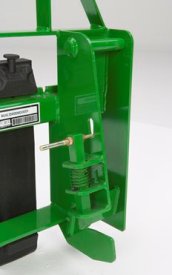 AB14D fits 600 and 700 Series Loaders
AB14D fits 600 and 700 Series Loaders
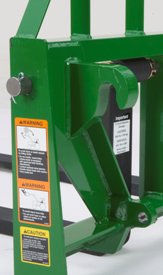 AB14G is global and fits all series loaders
AB14G is global and fits all series loaders
 AB14A fits 800 Series Loaders
AB14A fits 800 Series Loaders
The AB14 Series Bale Spears are equipped with quick-change, quick-attach, and global attaching systems. These systems create ease and accuracy for the operator. The proper attachments are as follows:
-
AB14D – 600 and 700 Series Loaders
-
AB14A – 800 Series Loaders
-
AB14G – Global Loaders
Replaceable tines for extended implement life
 Hardened steel tines enhance implement durability
Hardened steel tines enhance implement durability

The tines on the Frontier™ AB14 Series are made out of hardened steel and are replaceable.
Rugged, tubular frame built to withstand harsh conditions
 Rugged, tubular frame
Rugged, tubular frame

The frame on the Frontier™ AB14 Series is a square, tubular design, making it extremely strong and durable.
Features
Quick and easy attachment
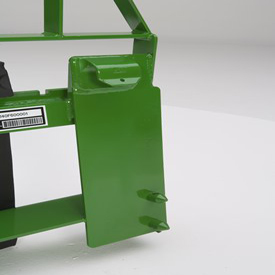 Fits John Deere 300CX Series Loaders
Fits John Deere 300CX Series Loaders
 Fits John Deere 600 and 700 Series Loaders
Fits John Deere 600 and 700 Series Loaders
 Fits John Deere global carrier
Fits John Deere global carrier
The AB11 and AB13 Series Bale Spears are equipped with a quick-change, global, and quick-attach attaching system. These systems save time and allow easy attachment for the operator.
The proper attachments are as follows:
- AB11E and AB13E - fits John Deere 300CX Series Loaders
- AB11D and AB13D - fits John Deere 600 and 700 Series Loaders
- AB11G and AB13G - fits John Deere Global Loaders
- AB13K - fits John Deere loaders with global Category 2 carriers
Replaceable tines for extended implement life
 Made of hardened steel
Made of hardened steel

The AB11 and AB13 Series Bale Spear tines are made out of hardened steel and replaceable.
Rugged, tubular frame enhances durability and efficiency
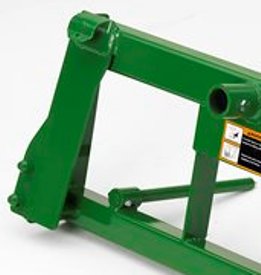 Bale spear frame for AB11 and AB13
Bale spear frame for AB11 and AB13

The frame on the AB11 and AB13 Series Bale Spear is constructed of a square, tubular design, making it extremely strong and durable.
Features
Rugged, tubular frame enhances durability and efficiency
 Frontier™ AB12 Series Bale Spear tubular frame
Frontier™ AB12 Series Bale Spear tubular frame

The frame on an AB12 Series Bale Spear is constructed of a square, tubular design, making it extremely strong and durable.
Quick, easy attachment
 Fits John Deere 600 and 700 Series Loaders
Fits John Deere 600 and 700 Series Loaders
 Fits John Deere Global Loaders
Fits John Deere Global Loaders
 Fits John Deere 800 Series Loaders
Fits John Deere 800 Series Loaders
The Frontier AB12 Series is equipped with quick-change, global, and quick-attach attaching systems. These systems save time and allow easy attachment for the operator.
The proper attachments are as follows:
- AB12E - fits John Deere 300CX Series Loaders
- AB12D - fits John Deere 600 and 700 Series Loaders
- AB12G - fits John Deere Global Loaders
- AB12A - fits 800 Series Loaders
Replaceable tines for extended implement life
 Replaceable tines
Replaceable tines

The AB12 Series tines are made out of hardened steel and are replaceable.
Features
Quick and easy attachment
 Fits John Deere 300CX Series Loaders
Fits John Deere 300CX Series Loaders
 Fits John Deere 600 and 700 Series Loaders
Fits John Deere 600 and 700 Series Loaders
 Fits John Deere global carrier
Fits John Deere global carrier
The AB11 and AB13 Series Bale Spears are equipped with a quick-change, global, and quick-attach attaching system. These systems save time and allow easy attachment for the operator.
The proper attachments are as follows:
- AB11E and AB13E - fits John Deere 300CX Series Loaders
- AB11D and AB13D - fits John Deere 600 and 700 Series Loaders
- AB11G and AB13G - fits John Deere Global Loaders
- AB13K - fits John Deere loaders with global Category 2 carriers
Replaceable tines for extended implement life
 Made of hardened steel
Made of hardened steel

The AB11 and AB13 Series Bale Spear tines are made out of hardened steel and replaceable.
Rugged, tubular frame enhances durability and efficiency
 Bale spear frame for AB11 and AB13
Bale spear frame for AB11 and AB13

The frame on the AB11 and AB13 Series Bale Spear is constructed of a square, tubular design, making it extremely strong and durable.
Features
Forged-steel bale spear tines are strong and long wearing
 Bolt-on spear tine is easy to replace if damaged
Bolt-on spear tine is easy to replace if damaged

Bale spear tines are made of forged steel to resist bending and provide longer wear capability.
These spear tines attach to the frame with a bolt fastener, making them much easier to replace if a tine is damaged.
Hitch provides a super-quick connection
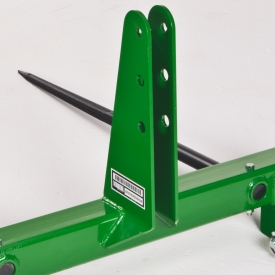 Quick and easy hitch system
Quick and easy hitch system
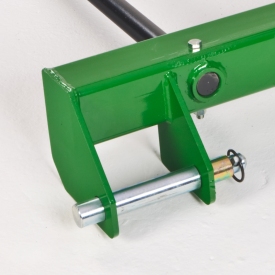 Hitch pins are included
Hitch pins are included
The single-spear HS2001 model is iMatch™ hitch system and quick-hitch compatible with Category 1 and 2 hitches.
The dual-spear HS2002 model is quick-hitch compatible with Category 2 and 3 hitches and also connects to Category 3N hitches.
Tubular frame is built strong
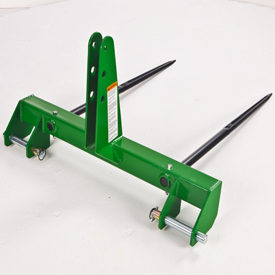 Sturdy tubular frame
Sturdy tubular frame

The strong tubular frame on the HS20 Series 3-Point Bale Spears can handle up to a 1.5-m x 1.8-m (5-ft x 6-ft) round bale.
Single-tine spears can hold up to 997.9 kg (2200 lb), while the dual-tine spears can handle up to 1360.8 kg (3000 lb).
Features
Adjustable bale arm fits round bale diameters of 152.4 cm to 177.8 cm (60 in. to 72 in.)
 Bale loading arm on the BC1108
Bale loading arm on the BC1108
 BC1110 bale loading arm
BC1110 bale loading arm
Frontier™ bale carriers have an adjustable bale arm to fit different bale sizes:
- BC1108 has a maximum bale diameter of 152.4 cm (60 in.)
- BC1110 has a maximum bale diameter of 177.8 cm (70 in.)
Model BC1110 has a bale loading arm designed for improved machine performance.
Bale carrier's low-profile design improves visibility and safety
 Great visibility when loading bales
Great visibility when loading bales
 Bale carrier when fully loaded
Bale carrier when fully loaded
Frontier™ bale carriers have been designed with a low profile to improve rearward visibility when loading or moving bales.
The low-profile design provides increased safety for operators.
Push bar moves bales to rear to make room for other bales
 Model BC1108 bale push bar
Model BC1108 bale push bar
 Model BC1110 bale push bar
Model BC1110 bale push bar
The bale push bar moves the bales rearward after they are loaded, making room for the next bale.
Walking beam axles and tires provide a smoother ride
 Tandem tires shown on BC1104 and BC1108
Tandem tires shown on BC1104 and BC1108
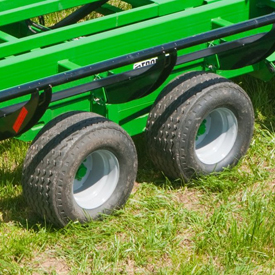 Flotation tires shown on BC1110
Flotation tires shown on BC1110
Walking beam axles, tandem tires, and larger flotation tires create a smoother ride on uneven or rough terrain.
Features
Adjustable tongue (hitch) folds out of way for easy repositioning of unit
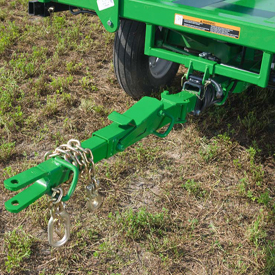 Adjustable tongue (hitch)
Adjustable tongue (hitch)

The adjustable tongue (hitch) folds neatly out of the way for wrapping. It is located at the opposite end of where the bales are wrapped.
The adjustable tongue makes moving and repositioning the machine a quick and easy task, saving time and money.
Control box and levers are control center of machine
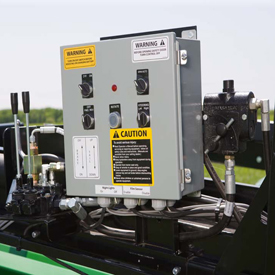 Multipurpose control center
Multipurpose control center

The control box and levers are the control center of the in-line bale wrappers.
Some of the uses include turning the unit on and off, and controlling the bale ramp and bale push.
Film wrap sensor shuts down wrapping cycle when out of film
 Sensor comprised of silver rod and limit switch
Sensor comprised of silver rod and limit switch

The film wrap sensor automatically shuts down the wrapping cycle when the machine runs out of film or breaks.
Traction implement tires great on wet and uneven terrain
 Assist in difficult field conditions
Assist in difficult field conditions

Traction implement tires make the in-line wrappers sure-footed on wet and uneven terrain to help get the machine where it needs to be for wrapping bales.
The LW11 Series comes standard with the traction implement tires, and they are available on the LW12 Series only when ordered with single- or dual-power drive.
Options available to increase productivity and uptime
14.9-kW (20-hp) Honda® engine
A larger horsepower engine with a high-flow pump provides increased capacity to complete the job faster.
NOTE: LW Series In-Line Bale Wrappers come standard with a 9.7-kW (13-hp) Honda engine.
Single- and dual-power drive
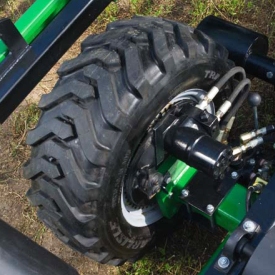 Optional single-power drive
Optional single-power drive
Optional single- or dual-power drives allow the operator to maneuver the unit without attaching it to a tractor. The single-power drive has one rear tire, while the dual-power drive has two rear tires, to provide traction for the unit. These features are great for wet or uneven ground conditions where traction is limited.
Steering remote control
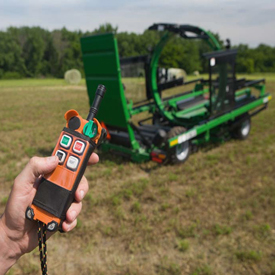 Remotely stops and starts the unit
Remotely stops and starts the unit
This remote control allows the operator to steer, start, and stop the machine without using the control panel on the machine.
Twin wrap kit
 Twin wrap kit
Twin wrap kit
This kit provides a double layer of wrap, increasing the amount of wrap applied to bales.
Work lights
 Lights allow operators to work longer hours
Lights allow operators to work longer hours
For early morning or late-night work, choose between two optional work lights: light-emitting diode (LED) and halogen.
Guide rollers
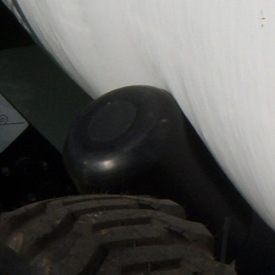 Optional guide rollers
Optional guide rollers
Optional guide rollers help keep the bales on the bale ramp in uneven terrain.
Power jack
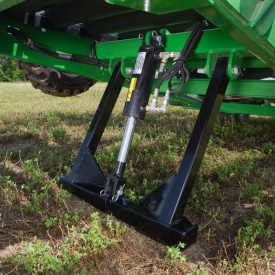 Power jack
Power jack
The optional power jack hydraulically raises the bale ramp to a level position to eliminate air pockets between bales when starting a row. The bale ramp is lowered after three bales have been wrapped.
Bale Follower
The bale follower allows the in-line wrapper to automatically follow the line of bales next to it.
Honda is a trademark of Honda Motor Co., Ltd.
Quick-start power jack for LW1266 Bale Wrappers
The quick-start power jack conversion kit lifts the bale wrapper to level the roller bed when starting a new bale line on the LW1266 In-Line Bale Wrappers.
Light kit for bale wrapper
A conversion kit provides night working lights on LW1166 and LW1266 In-Line Bale Wrappers.
Remote steering and shutdown conversion kits for LW11 and LW12 Bale Wrappers
Remote steering and shutdown conversion kits allow the operator to steer and start/stop the wrapper from the operator station of the tractor or from the skid steer that is loading the bales into the wrapper.
Guide rollers conversion kit for LW12 Series Bale Wrappers
This sidehill guide rollers conversion kit prevents bales from sliding off of the rollers when wrapping on hillsides.
Features
Adjustable tongue (hitch) folds out of way for easy repositioning of unit
 Adjustable tongue (hitch)
Adjustable tongue (hitch)

The adjustable tongue (hitch) folds neatly out of the way for wrapping. It is located at the opposite end of where the bales are wrapped.
The adjustable tongue makes moving and repositioning the machine a quick and easy task, saving time and money.
Bale push is integrated into machine
 Optional bale push-off arm
Optional bale push-off arm
 Operator needs to extend arm
Operator needs to extend arm
The bale push moves the bale to the back of the bale wrapper. From this point, the operator can utilize the optional bale push-off arm to finish the process. The operator moves a lever to extend the arm, and the arm pushes the bale off onto the ground.
Control box and levers are control center of machine
 Multipurpose control center
Multipurpose control center

The control box and levers are the control center of the in-line bale wrappers.
Some of the uses include turning the unit on and off, and controlling the bale ramp and bale push.
Film wrap sensor shuts down wrapping cycle when out of film
 Sensor comprised of silver rod and limit switch
Sensor comprised of silver rod and limit switch

The film wrap sensor automatically shuts down the wrapping cycle when the machine runs out of film or breaks.
Traction implement tires great on wet and uneven terrain
 Assist in difficult field conditions
Assist in difficult field conditions

Traction implement tires make the in-line wrappers sure-footed on wet and uneven terrain to help get the machine where it needs to be for wrapping bales.
The LW11 Series comes standard with the traction implement tires, and they are available on the LW12 Series only when ordered with single- or dual-power drive.
Options available to increase productivity and uptime
14.9-kW (20-hp) Honda® engine
A larger horsepower engine with a high-flow pump provides increased capacity to complete the job faster.
NOTE: LW Series In-Line Bale Wrappers come standard with a 9.7-kW (13-hp) Honda engine.
Single- and dual-power drive
 Optional single-power drive
Optional single-power drive
Optional single- or dual-power drives allow the operator to maneuver the unit without attaching it to a tractor. The single-power drive has one rear tire, while the dual-power drive has two rear tires, to provide traction for the unit. These features are great for wet or uneven ground conditions where traction is limited.
Steering remote control
 Remotely stops and starts the unit
Remotely stops and starts the unit
This remote control allows the operator to steer, start, and stop the machine without using the control panel on the machine.
Twin wrap kit
 Twin wrap kit
Twin wrap kit
This kit provides a double layer of wrap, increasing the amount of wrap applied to the bales.
Bale follower
The bale follower allows the in-line wrapper to automatically follow the line of bales next to it.
Work lights
 Lights allow operators to work longer hours
Lights allow operators to work longer hours
For early morning or late-night work, choose between two optional work lights: light-emitting diode (LED) and halogen.
Honda is a trademark of Honda Motor Co., Ltd.
Light kit for bale wrapper
A conversion kit provides night working lights on LW1166 and LW1266 In-Line Bale Wrappers.
Remote steering and shutdown conversion kits for LW11 and LW12 Bale Wrappers
Remote steering and shutdown conversion kits allow the operator to steer and start/stop the wrapper from the operator station of the tractor or from the skid steer that is loading the bales into the wrapper.
Wheel conversion kits for LW11 and LW12 Bale Wrappers
The first kit listed is a dual-wheel hydraulic power drive conversion kit that allows the wrapper to be driven and powered by its own hydraulic system. Dual drive improves traction in wet and slick conditions.
The second kit listed is a single-wheel hydraulic power drive conversion kit that allows the wrapper to be driven and powered by its own hydraulic system. One rear tire is hydraulically driven.
Features
Versatile, productive, and durable premium pickup
Premium pickup
 Premium – five tine bar – pickup
Premium – five tine bar – pickup
 Tine bars made of steel with a central spider reinforcement
Tine bars made of steel with a central spider reinforcement
The C451R pickup features premium components such as:
- 2.20-m (7.2-ft) wide pickup, with a 1.92-m (6.3-ft) tine-to-tine distance provides comfort and speed capacity when harvesting the largest swaths.
- Five tine bars - the fifth bar allows the tines to rake two more times per second versus a four-tine pickup.
- O-shaped tubular tine bars with central spider reinforcement - tine bars are assembled with ball bearings on the central spider, and central spiders limit tine bars bending in heavy crops.
- 6.0-mm (0.23-in.) diameter tines provide high strength to harvest the toughest crops.
- Stainless-steel strippers provide gliding capacity no matter the material, and are resistant to acid damage that can be caused by the use of additives such as propionic acid.
High-quality crops and smooth flow with High-Capacity (HC) Premium rotors
The C451R HC rotor
 Rotor and converging augers aligned on a single axle
Rotor and converging augers aligned on a single axle
 Left, HC rotor; Right, classic rotor design
Left, HC rotor; Right, classic rotor design
By using the HC Premium rotor – a feature available on John Deere round balers since 2012 – the C451R feeding system offers:
- Limited distance from the pickup to rotor tines to reduce plugging, especially in brittle straw or short silage
- Reduced number of bearings and distributed loads along the rotor to increase reliability
- Large 48-cm (18.9-in.) diameter converging augers facilitate crop transfer
This smooth crop flow enables high feeding capacity in short crops such as brittle straw or sticky silage.
MaxiCut HC 25 Premium provides high-quality fine chopped crops
 MaxiCut HC 25 Premium rotor
MaxiCut HC 25 Premium rotor
 Two knives sets can be managed from the monitor
Two knives sets can be managed from the monitor
The 25-knife, High-Capacity Premium precutter features:
- 50-cm (19.7-in.) diameter rotor for increased feeding capacity
- Hardox wear plate material provides a long lifespan and high resistance to foreign objects
- Three tines per turn
- Tines fully enclosing the tube, giving higher tine resistance and longer component lifetime
The - precutter function offers additional features such as:
- 0/12/13/25 knife engagement from the display. No need to leave the cab to manage knives. When used alone, the 12 or 13 knives set provides a regular 80-mm (3.1-in.) knife spacing and limited power consumption. When paired together, knife spacing is reduced to 40 mm (1.6 in.).
- Heavy-duty knives require less fuel consumption and sharpening operations. When cutting at a regular 80-mm (3.1-in.) length, the two independent knife sets extend time between each sharpening process by using the first knife set one day and the second one on the next day (time between each sharpening process given can vary greatly depending on crop type and number of bales).
- Individual spring-loaded knives prevent component damage when foreign objects are ingested. Compared to a shear bolt or full-set hydraulic system, this technology limits effort on the knives and/or provides a real non-stop protection.
Exclusive drop-floor concept removes the worst plugs
Drop floor provides a constant free space to remove plugs
 40-mm (1.57-in.) free space under the rotor
40-mm (1.57-in.) free space under the rotor
 Full rotor width drop floor avoids bottleneck noticed with other concepts
Full rotor width drop floor avoids bottleneck noticed with other concepts
The C451R Baler comes with a drop-floor unplugging system. In case of clog, the drop floor is managed from the display simultaneously or independently from the knives. When lowering the floor, the drop floor system provides 40-mm (1.57-in.) of free space under the rotor and converging augers.
By providing a constant free space, the John Deere drop floor avoids bottlenecks existing on balers using movable floors with front or rear hinges. No need to have an opening (that sometimes causes crop loss), only a few free centimeters (inches) are enough to remove the plug.
 Full-width drop floor removes clogs under converging augers
Full-width drop floor removes clogs under converging augers
The worst plugs generally happen when turning with the baler. In such situations, the crops are blocked under the converging augers and the clog must be manually removed. The unique John Deere drop floor features a full width, protecting the full pickup and rotor width. Even when plugged at the converging auger level, the clog can be easily removed by the operator from the cab.
MaxD (Maximum Density) bale chamber pushes versatility and bale weights
Offset density arm provides tension to the belts
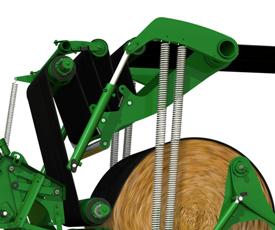 Offset density arm gives tension to the belts
Offset density arm gives tension to the belts
 Simple density settings from monitor
Simple density settings from monitor
The C451R density is provided by an offset tension arm that applies hydraulic tension to the belts and not directly to the bale. This heavy-duty component is not involved in belt length compensation, so 100 percent of hydraulic power is involved in belt tensioning.
Density is easily set from the monitor and can be adjusted from 0 to 100 percent of hydraulic pressure. A virtual gauge located on the main working page continuously follows the density increase without looking back to the baler.
Density can also be adjusted manually from the hydraulic valve in case of major failure.
Wide endless belts provide density and reduce crop loss
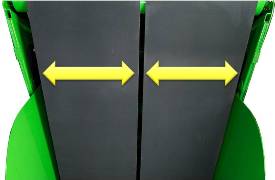 Only two belts - advanced belt tracking allows the operator to work in all conditions
Only two belts - advanced belt tracking allows the operator to work in all conditions
The C451R Round Baler features two wide 573-mm (22.56-in.) belts. Using two belts optimizes bale coverage and limits crop loss.
To handle the pressure transmitted by the density arm, the belts have no laces.
An advanced belt tracking system, including wide front pulleys and several guides located throughout the chamber, ensures accurate belt positioning, even when working in slopes or when overloading one side of the pickup. All edges of parts that could potentially come in contact with the belts are chamfered to avoid belt side damage. A take-up arm provides belt tension during the gate cycle process to avoid potential belt tracking issues.
Belts are driven by two large-diameter rubber rolls with a large contact surface to prevent belt slippage in wet conditions. Springs linked to the density arm are located on both sides of the chamber and give tension to the belts during bale starting.
The C451R has a few features to limit crop from sticking. The belts feature a smooth pattern. Paddles on belt drive rolls, cleaning augers into the density arm, and other scrapers located in several places through the belts paths continuously clean the belts and remove crop accumulation around the bale chamber.
Bale chamber rolls make easy bale starting in all conditions
 Driven bale chamber rolls rotate crops immediately
Driven bale chamber rolls rotate crops immediately
MaxD bale chamber features three powered rolls:
- The three powered rolls facilitate bale starting, especially in wet conditions such as silage. Forage immediately turns into the chamber, and there is no slipping risk even with the heaviest bales.
- Rolls are positioned to give the bale a perfectly round shape, regardless of the bale diameter, and the core is centered.
- As belts push crops against rigid steel rolls, high pressure is applied to produce high-density bales.
Heavy-duty components ensure high density and durability
 Reinforced bale chamber components (in red)
Reinforced bale chamber components (in red)
Heavy bales, high density, high baling speed, and high tractor power directly impacts baler durability. The C451R Round Baler includes several heavy-duty components into the bale chamber to meet growers' expectations:
- The front part of the bale chamber (front side sheets) is made with Hardox® steel plates to limit impact of aggressive crop friction.
- Lower Fast Release System (FRS) roll handling a large part of the bale weight features extra thickness (plus 40 percent versus standard rolls) for extended durability.
- Tailgate frame is specially reinforced around the lock to handle high tension.
- Top belts driving roll receive a special heat tempering.
Standard softcore system provides on-the-go adjustability
 Softcore is fully adjustable from monitor
Softcore is fully adjustable from monitor
The C451R benefit from an advanced softcore system management:
- Bale core density (different from the overall bale density) can be adjusted from 0 to 100 percent of maximum density capacity from the monitor.
- Bale core diameter can be set from the monitor.
- Softcore system can be activated/deactivated from the display.
Accurate softcore settings allow:
- Production of better-quality forage when harvesting crops with residual moisture.
- To easily unroll core of bales.
Hardox is a trademark of SSAB Technology AB.
Fast Release System (FRS) – a key to unbeaten productivity
Why each second counts
The size of the tailgate directly impacts bale transfer time, and the bale chamber unloading system is a critical component in a wrapping baler.
John Deere FRS greatly decreases non-productive time and directly boosts overall baler productivity.
There is an advantage to the baler compactness: by using a vertical folding structure, the C451R allows a quick transfer right after the bale has been unloaded from the chamber. FRS can close as soon as the bale leaves the unloading areas and the baling process can restart a short time after the bale has been ejected from the chamber.
On all other wrapping balers, the bale must first reach a far enough position before the tailgate can close (to avoid bale/tailgate interference risk). This transfer requires time and keeps the baler wrapping from restarting quickly.
Lighter tailgate means faster tailgate
 Simple parts to move to open the tailgate
Simple parts to move to open the tailgate
 230-kg (507-lb) FRS can be moved quickly
230-kg (507-lb) FRS can be moved quickly
FRS provides a light structure, less than half of the traditional tailgate weight that opens the chamber quickly and removes belts from the bale.
Compared to a traditional tailgate:
- FRS can be actuated by fast cylinders with reduced dampening needs.
- FRS impacts the baler’s lifetime in a reduced way. Moving less than 250 kg (551 lb) puts less stress on the frame than moving 600 kg (1322.8 lb) in a similar time.
- FRS pivot is located at the center of the chamber, not on the top of the baler. Motion is even faster and center of gravity is not impacted much by tailgate position.
Moving side sheets release the bale faster
 Side of the chamber moves
Side of the chamber moves
Moving side sheets help prevent the bale from getting stuck in the chamber. When the light structure opens, each side of the chamber automatically moves 50 mm (2 in.). There is no more contact between the bale and the chamber; the bale is released and quickly falls by its own weight. Even in wet conditions, the unloading process is as efficient as in dry straw.
This unique feature does not require complicated hydraulic or mechanical systems to be actuated. When the tailgate goes down, simple bearings push on cams located on both side sheets and lock the chamber sides in the baling position. When the tailgate opens, the pressure on the side sheets cam is automatically released, then a return spring quickly moves the chamber walls outside.
Locks located on both baler sides lock the FRS when the tailgate is closed.
35-rpm wrapping arms - bale faster than ever
Balanced cycle time between baling and bale wrapping functions is key
 Wrap a bale with film every 39 seconds
Wrap a bale with film every 39 seconds
The design of a productive baler is not sufficient if the film wrapping unit is not able to follow the same rhythm of work. John Deere engineers came up with smart solutions to eliminate bottle necks and boost total productivity.
Cycle times have been decreased and the system allows a bale wrapped with six layers of film every 39 seconds, meaning a maximum productivity of 92 bales per hour. This performance is from 7 percent to 22 percent better than others in the worldwide market.
To achieve such productivity, John Deere uses an innovative and powerful hydraulic motor which can drive the film wrapping arm at a 35-rpm speed.
Changing film rolls is quick and easy
 12 film rolls can be loaded on the C451R
12 film rolls can be loaded on the C451R
The C451R is equipped with a unique film roll storage device. Each film roll weighs about 20 kg (44 lb) and must be changed often; this system has been designed to simplify loading and unloading operations.
On each side of the machine, five rolls are installed on a moving arm, hydraulically piloted. The loading/unloading position has been set up to be as close as possible to the wrapping arms at an ergonomic height.
Details count: in the transport position, the film storage device is covered by a roof which protects film rolls from rain. This protects the film roll core, often made of cardboard, from damage.
Advanced displays and electronics allow the operator to customize the baler
All settings from the monitor
 Main page with simple and clear pictures
Main page with simple and clear pictures
 No need to leave the cab to adjust the baler
No need to leave the cab to adjust the baler
The C451R Wrapping Baler both use ISOBUS architecture and can be set from the display. There is no need for the operator to leave the cab, even for density or greasing (when equipped with optional automatic greasing system), as everything is managed from drop-down menus.
The C451R offers:
Baler settings
- Knife engagement/disengagement
- Knife set management (when equipped with MaxiCut™ HC 25 Premium)
- Drop floor lowering/raising
- Bale diameter adjustment
- Bale density adjustment (0 to 100 percent capacity)
- Softcore activation/deactivation
- Softcore pressure adjustment (0 to 100 percent capacity)
- Softcore diameter adjustment
- Net/twine choice
- Automatic/manual tying/wrapping starting
- Manual net/twine cylinder control
- Net layers adjustment
- Net tying delay adjustment
- Twine turns on each side (independent) adjustment
- Twine spacing adjustment
- Twine space to the edges adjustment
- B-Wrap® wrapping system mode activation
- Automatic greasing system engagement/disengagement (when equipped with optional automatic greasing system)
- Automatic greasing duration and frequency
Wrapping unit settings
- Automatic/manual tailgate opening and bale transfer
- Transport table speed curve
- Number of film layers
- Automatic/manual wrapping
- Wrapping arm speed curve
- On the go/when stopped/manual/grouper mode dumping
- Dumping speed curve
- Lighting (side lights/beacon) control when option selected
Baler information
- Bale shape indicators
- Current bale diameter/set bale diameter
- Current bale density/set bale density
- Knife set position
- Drop-floor position
- Near full alarm
- Stop indicator
- Net/twine choice
- Net/twine process status
- Tailgate status
- Softcore status
- Bale counters (10 operators x 10 fields = 100 counters)
- Time counter
- Clear error message
Wrapping unit information
- Transport table position
- Wrapping arms position
- Wrapping process status (number of applied layers)
- Dumping status
- Greasing status
- Lighting status
4240 Universal Display enhances operator comfort
NOTE: Limited availability for model year 2019.
 4240 Universal with C451R main working page
4240 Universal with C451R main working page
The C451R can be delivered with various monitors. At the top of the baler range, the 4240 Universal Display can be ordered. This monitor features a 21.5-cm (8.5-in.) diagonal color display. The touchscreen offers an intuitive and user-friendly interface that easily allows operators to adjust and control various settings.
To be used with ISOBUS or non-ISOBUS tractors, the GreenStar 4240 Display option is delivered with the following components:
- 4240 Universal Display
- Baler to rear tractor ISOBUS plug
- Baler ISOBUS plug to display harness – plugged into tractor battery
- Tractor cab corner to monitor harness
NOTE: GreenStar™ 2 2600 Displays are not compatible. There is not sufficient memory to handle the software payload.
The operator's own ISOBUS monitor can be used to optimize cost of acquisition and/or comfort
For operators already using a built-in or external ISOBUS certified display, the C451R Baler can be delivered without a monitor. Thanks to the ISOBUS connectivity, just plug the baler to the tractor/monitor and bale.
B-Wrap is a trademark of Tama Plastic Industry.
| Option code | Description |
| 7309 | No monitor – ISOBUS baler |
| 7312 | GreenStar 4240 – ISOBUS baler |
Features
Hydraulic wing and rear deck lifts enable automatic locking for transport
 Cylinder latch position for transport
Cylinder latch position for transport

The FM3012 has hydraulic lifts for the wing and rear decks, to automatically lock them in the up position for transport. A rope-pull latch release comes standard.
NOTE: An optional hydraulic-wing latch release kit is available.
Reinforced cast-iron blade spindles provide long life and strength
 FM3012 blade spindle assembly
FM3012 blade spindle assembly

The FM3012 has cast-iron, reinforced blade spindles with ball bearings that can be greased for increased strength and long life.
Tubular caster arm supports prolong the life of the mower
 Tubular caster arms shown
Tubular caster arms shown

The heavy tubular caster arms supports are designed to prolong the life of the FM3012 Flex-Wing Grooming Mower.
Gearbox comes with three-year warranty
 Three-year residential gearbox warranty
Three-year residential gearbox warranty
The FM3012's gearbox has a three-year residential warranty.
Transport width of 2362 mm (93 in.) enables storage in a standard-sized garage
 Unit in transport position shown
Unit in transport position shown

The FM3012 has a transport width of 2362 mm (93 in.), which allows storage in a standard-sized garage.
Anti-scalping rollers provide a uniform cut
 Front-mounted roller shown
Front-mounted roller shown

Each deck on the FM3012 has three anti-scalping rollers that keep the deck following the ground contour for a more uniform cut.
116-mm (4.6-in.) deck skirt ensures exceptional cut quality and material distribution
 Deck depth ensures optimum cut quality
Deck depth ensures optimum cut quality

The FM3012 deck depth with baffling around the blades ensures exceptional material distribution and a higher quality of cut.
Features
Anti-scalping rollers
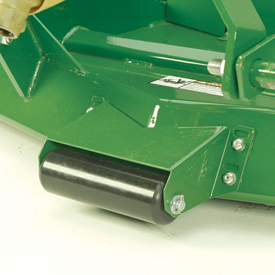 Mounted to front of mower
Mounted to front of mower

Anti-scalping rollers are mounted to the front of each cutting deck on the FM20 and FM21 Series Flex-Wing Grooming Mowers.
Free-floating mower deck
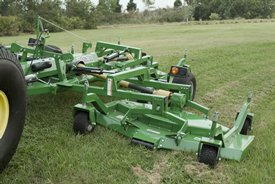 Creates a clean, even finish
Creates a clean, even finish

The FM20 and FM21 Series Flex-Wing Grooming Mowers have completely independent free-floating mowing decks that provide a perfect cut on uneven terrain.
Spiral gearbox gears transfer more power
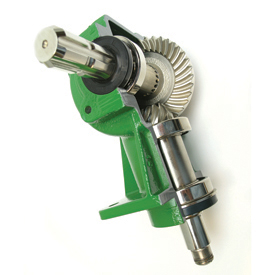 Gearbox enhances overall mower performance
Gearbox enhances overall mower performance

The rugged gearbox on the FM Series Flex-Wing Grooming Mowers features spiral gears to dramatically reduce noise, increase endurance, and transfer more power to the blades.
Pneumatic tires put less pressure on the ground
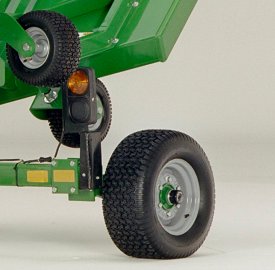 Ideal for use on golf courses and sport fields
Ideal for use on golf courses and sport fields

The pneumatic tires on the FM20 and FM21 Series Flex-Wing Grooming Mowers put less pressure on the ground, making them ideal for use on golf courses and sport fields.
Telescoping wings for adjustable cutting width
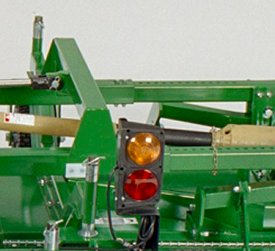 Adjust to the cutting width of choice
Adjust to the cutting width of choice

The telescoping wings on the FM20 and FM21 Series Flex-Wing Grooming Mowers allow for adjustable cutting widths to increase or decrease mower overlap for slope applications.
Auto-engage transport latch
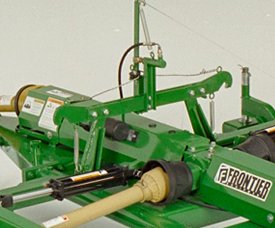 Latch automatically engages
Latch automatically engages
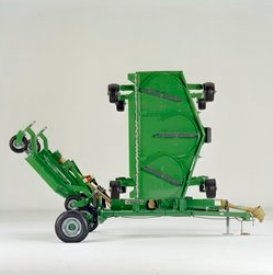 Transport position
Transport position
For added safety, the transport latching mechanism on the FM Series Flex-Wing Grooming Mower automatically engages when the decks are raised into the transport position.
Floating hitch kit for FM20 and FM21 Series Flex-Wing Grooming Mowers
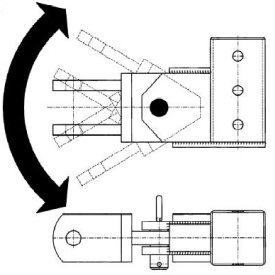 Drawing from operator manual
Drawing from operator manual

The optional floating hitch is for undulating terrain, providing increased flexibility and mowing results.
Mulching kits for grooming mowers
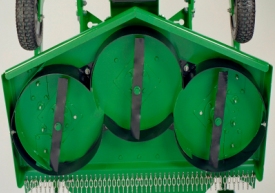 Kit includes baffles, blades, and guard supports
Kit includes baffles, blades, and guard supports

A mulching kit is available as an attachment for field conversion. The mulching kit includes unique mulching blades, baffles, and guard supports to produce smaller clippings, which decompose faster than clippings that haven't been mulched.
Operators should follow the one-third rule for cutting height when mulching in grass.
This mulching kit also does an excellent job when mulching leaves.
Hydraulic unlock system conversion kit for FM20 and FM21 Series Flex-Wing Grooming Mowers
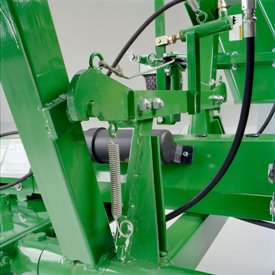 Replaces standard rope disengagement
Replaces standard rope disengagement

The hydraulic unlock system field conversion kit is available for FM20 and FM21 Series Flex-Wing Grooming Mowers.
This conversion kit allows the operator to unlock the wings from the tractor seat with the convenience of a hydraulic lever. It replaces the standard rope disengagement that comes with the flex-wing mower.
The hydraulic unlock system requires one additional selective control valve (SCV) (two total) and is ideal for lawn services that fold and unfold the unit to go from job to job.
Features
Anti-scalping rollers
 Mounted to front of mower
Mounted to front of mower

Anti-scalping rollers are mounted to the front of each cutting deck on the FM20 and FM21 Series Flex-Wing Grooming Mowers.
Auto-engage transport latch
 Latch automatically engages
Latch automatically engages
 Transport position
Transport position
For added safety, the transport latching mechanism on the FM Series Flex-Wing Grooming Mower automatically engages when the decks are raised into the transport position.
Choose from various cutting blades
 Three blades per deck
Three blades per deck

To meet specific mowing needs, choose from four blade types:
- Standard
- Mulching
- High lift
- Flat
Free-floating mower deck
 Creates a clean, even finish
Creates a clean, even finish

The FM20 and FM21 Series Flex-Wing Grooming Mowers have completely independent free-floating mowing decks that provide a perfect cut on uneven terrain.
Pneumatic tires put less pressure on the ground
 Ideal for use on golf courses and sport fields
Ideal for use on golf courses and sport fields

The pneumatic tires on the FM20 and FM21 Series Flex-Wing Grooming Mowers put less pressure on the ground, making them ideal for use on golf courses and sport fields.
Spiral gearbox gears transfer more power
 Gearbox enhances overall mower performance
Gearbox enhances overall mower performance

The rugged gearbox on the FM Series Flex-Wing Grooming Mowers features spiral gears to dramatically reduce noise, increase endurance, and transfer more power to the blades.
Telescoping wings for adjustable cutting width
 Adjust to the cutting width of choice
Adjust to the cutting width of choice

The telescoping wings on the FM20 and FM21 Series Flex-Wing Grooming Mowers allow for adjustable cutting widths to increase or decrease mower overlap for slope applications.
Floating hitch kit for FM20 and FM21 Series Flex-Wing Grooming Mowers
 Drawing from operator manual
Drawing from operator manual

The optional floating hitch is for undulating terrain, providing increased flexibility and mowing results.
Mulching kits for grooming mowers
 Kit includes baffles, blades, and guard supports
Kit includes baffles, blades, and guard supports

A mulching kit is available as an attachment for field conversion. The mulching kit includes unique mulching blades, baffles, and guard supports to produce smaller clippings, which decompose faster than clippings that haven't been mulched.
Operators should follow the one-third rule for cutting height when mulching in grass.
This mulching kit also does an excellent job when mulching leaves.
Hydraulic unlock system conversion kit for FM20 and FM21 Series Flex-Wing Grooming Mowers
 Replaces standard rope disengagement
Replaces standard rope disengagement

The hydraulic unlock system field conversion kit is available for FM20 and FM21 Series Flex-Wing Grooming Mowers.
This conversion kit allows the operator to unlock the wings from the tractor seat with the convenience of a hydraulic lever. It replaces the standard rope disengagement that comes with the flex-wing mower.
The hydraulic unlock system requires one additional selective control valve (SCV) (two total) and is ideal for lawn services that fold and unfold the unit to go from job to job.
Features
Spiral gearbox gears transfer more power
 Gearbox enhances overall mower performance
Gearbox enhances overall mower performance

The rugged gearbox on the FM Series Flex-Wing Grooming Mowers features spiral gears to dramatically reduce noise, increase endurance, and transfer more power to the blades.
Auto-engage transport latch
 Latch automatically engages
Latch automatically engages
 Transport position
Transport position
For added safety, the transport latching mechanism on the FM Series Flex-Wing Grooming Mower automatically engages when the decks are raised into the transport position.
Anti-scalping front roller conversion kits for GM10, GM30, and FM10 Series Grooming Mowers
An anti-scalping front roller kit can be ordered as an attachment for field conversion for FM and GM Series Grooming Mowers when not standard equipment. The roller is attached to the front of the cutting deck to help reduce scalping.
Each kit contains one roller.
Anti-streaking kit for FM10 Series Grooming Mowers
The anti-streaking kit is available for FM10 Series Flex-Wing Grooming Mowers as an aftermarket field conversion kit.
Light bar for FM10 Series Flex-Wing Grooming Mowers
 Includes lights, harness, and brackets
Includes lights, harness, and brackets

The light bar is standard on these units; however, it is also offered as an aftermarket field conversion kit rather than ordering each piece separately through Parts. It includes two lights, a harness, and required brackets.
Features
Caster wheels follow ground contours and prevent scalping
 Four caster wheels follow ground contours
Four caster wheels follow ground contours

By having four caster wheels, the GM30 Series Grooming Mower follows ground contours and prevents scalping. Heavy tubular caster wheel arms are bolted to rail supports for long life.
Floating hitch for level cutting
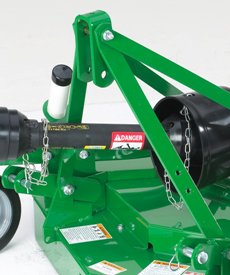 Smooth, level finish
Smooth, level finish

The floating hitch on the GM30 Series keeps the deck tracking over ground contours for a level and smooth cut.
High blade-tip speed
 Provides a quality cut
Provides a quality cut

High blade-tip speed and precise blade overlap work together to ensure exceptional strength, performance, and a quality cut.
Rugged gearbox with cooling fins
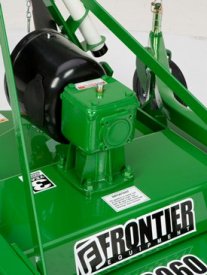 Gearbox with 18.6 to kW to 22.4 kW (25 hp to 35 hp) for longer life
Gearbox with 18.6 to kW to 22.4 kW (25 hp to 35 hp) for longer life

The GM30 Series Grooming Mowers come with a 18.6-kW to 22.4-kW (25-hp to 35-hp) rugged gearbox. Cooling fins help extend the life of the gearbox.
Choose from various cutting blades
 Three blades per deck
Three blades per deck

To meet specific mowing needs, choose from four blade types:
- Standard
- Mulching
- High lift
- Flat
Tapered deck increases maneuverability
 Deck design increases overall productivity
Deck design increases overall productivity

The tapered deck design on the GM30 Series increases maneuverability and allows closer mowing around obstacles. The deep deck design allows greater cutting volume and a cleaner cut.
iMatch™ quick-hitch conversion kits for grooming mowers
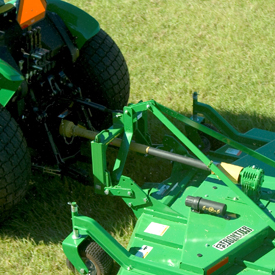 iMatch quick-hitch
iMatch quick-hitch
One of the greatest concerns for operators involves difficulty in attaching tractor implements. John Deere has addressed this issue with the iMatch quick-hitch sytem.
The iMatch quick-hitch provides easy hookup and a guaranteed fit for all Category 1 implements designed to meet the ASAE Category 1 Standard S278.6 for quick-attach hitches.
All implements require a set of bushings in order for the attachment to fit and work properly with the iMatch quick-hitch. One set of bushings comes with the iMatch quick-hitch. Additional bushings are available from a John Deere dealer.
Anti-scalping front roller conversion kits for GM10, GM30, and FM10 Series Grooming Mowers
An anti-scalping front roller kit can be ordered as an attachment for field conversion for FM and GM Series Grooming Mowers when not standard equipment. The roller is attached to the front of the cutting deck to help reduce scalping.
Each kit contains one roller.
Rear chain shield conversion kit for grooming mowers
 Prevents debris from flying out from under deck
Prevents debris from flying out from under deck

A rear chain shield kit is available as an attachment for field conversion. It assists in preventing debris from flying out from underneath the deck of the rear-discharge grooming mowers.
Features
Rugged gearbox with cooling fins
 Cooling fins help extend life of the gearbox
Cooling fins help extend life of the gearbox

The GM11 and GM21 Series Medium-Duty Grooming Mowers come with a 37.3-kW (50-hp) rugged gearbox. Cooling fins help extend the life of the gearbox.
Quick and easy height adjustments
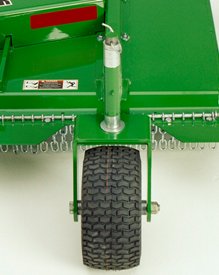 Spacers make for quick and easy height adjustment
Spacers make for quick and easy height adjustment

The GM21 Series Medium-Duty Grooming Mowers' stamped wheel yokes with air tires have spacers for quick and easy height adjustment.
Quality cut with high blade-tip speed
 High blade-tip speed increases productivity
High blade-tip speed increases productivity

The high blade-tip speed and precise blade overlap work together to ensure exceptional strength, performance, and a quality cut when using the Frontier™ grooming mowers.
NOTE: Image shown is of GM21 Series Standard-Duty Grooming Mower.
Deck design increases productivity
 Rounded front enhances mower efficiency
Rounded front enhances mower efficiency

The GM11 and GM21 Series Medium-Duty Grooming Mowers have a rounded, front-tapered rear deck design that allows for close mowing along trees, fences, buildings, and other obstacles.
iMatch™ quick-hitch conversion kits for grooming mowers
 iMatch quick-hitch
iMatch quick-hitch
One of the greatest concerns for operators involves difficulty in attaching tractor implements. John Deere has addressed this issue with the iMatch quick-hitch sytem.
The iMatch quick-hitch provides easy hookup and a guaranteed fit for all Category 1 implements designed to meet the ASAE Category 1 Standard S278.6 for quick-attach hitches.
All implements require a set of bushings in order for the attachment to fit and work properly with the iMatch quick-hitch. One set of bushings comes with the iMatch quick-hitch. Additional bushings are available from a John Deere dealer.
Features
Gearbox with spiral gears
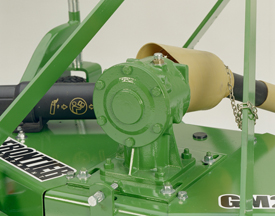 Highly engineered and rugged for extra strength
Highly engineered and rugged for extra strength
 Gearbox cutaway
Gearbox cutaway
The rugged gearbox on the GM20 Series Standard-Duty Grooming Mowers feature highly engineered spiral gears to dramatically reduce noise, increase endurance, and transfer more power to the cutting blades.
Safety chain shield
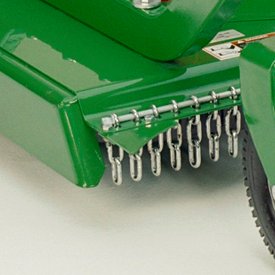 Standard chain shield for added safety
Standard chain shield for added safety
GM20 Series Grooming Mowers come standard with a safety chain shield.
Choose from various cutting blades
 Three blades per deck
Three blades per deck

To meet specific mowing needs, choose from four blade types:
- Standard
- Mulching
- High lift
- Flat
iMatch™ quick-hitch conversion kits for grooming mowers
 iMatch quick-hitch
iMatch quick-hitch
One of the greatest concerns for operators involves difficulty in attaching tractor implements. John Deere has addressed this issue with the iMatch quick-hitch sytem.
The iMatch quick-hitch provides easy hookup and a guaranteed fit for all Category 1 implements designed to meet the ASAE Category 1 Standard S278.6 for quick-attach hitches.
All implements require a set of bushings in order for the attachment to fit and work properly with the iMatch quick-hitch. One set of bushings comes with the iMatch quick-hitch. Additional bushings are available from a John Deere dealer.
Mulching kits for grooming mowers
 Kit includes baffles, blades, and guard supports
Kit includes baffles, blades, and guard supports

A mulching kit is available as an attachment for field conversion. The mulching kit includes unique mulching blades, baffles, and guard supports to produce smaller clippings, which decompose faster than clippings that haven't been mulched.
Operators should follow the one-third rule for cutting height when mulching in grass.
This mulching kit also does an excellent job when mulching leaves.
Anti-scalping roller conversion kits for GM10E, GM11, and GM20 Series Grooming Mowers
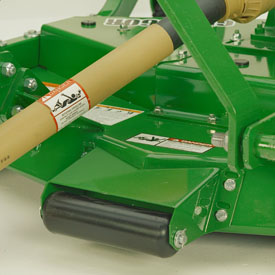 Anti-scalping roller attaches to front of deck
Anti-scalping roller attaches to front of deck

An anti-scalping roller kit can be ordered as an attachment for field conversion for FM and GM Series Grooming Mowers when it is not standard equipment. The roller is attached to the front of the cutting deck to help reduce scalping.
Each kit contains one roller.
Features
Caster wheels prevent scalping
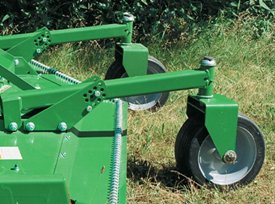 Four caster wheels prevent scalping
Four caster wheels prevent scalping

Four caster wheels follow ground contours and prevent scalping. Heavy tubular caster wheel arms are bolted to rail supports for long life.
Deck design increases productivity
 Rounded front enhances mower efficiency
Rounded front enhances mower efficiency

The GM11 and GM21 Series Medium-Duty Grooming Mowers have a rounded, front-tapered rear deck design that allows for close mowing along trees, fences, buildings, and other obstacles.
Rugged gearbox with cooling fins
 Cooling fins help extend life of the gearbox
Cooling fins help extend life of the gearbox

The GM11 and GM21 Series Medium-Duty Grooming Mowers come with a 37.3-kW (50-hp) rugged gearbox. Cooling fins help extend the life of the gearbox.
Anti-scalping roller conversion kits for GM10E, GM11, and GM20 Series Grooming Mowers
 Anti-scalping roller attaches to front of deck
Anti-scalping roller attaches to front of deck

An anti-scalping roller kit can be ordered as an attachment for field conversion for FM and GM Series Grooming Mowers when it is not standard equipment. The roller is attached to the front of the cutting deck to help reduce scalping.
Each kit contains one roller.
iMatch™ quick-hitch conversion kits for grooming mowers
 iMatch quick-hitch
iMatch quick-hitch
One of the greatest concerns for operators involves difficulty in attaching tractor implements. John Deere has addressed this issue with the iMatch quick-hitch sytem.
The iMatch quick-hitch provides easy hookup and a guaranteed fit for all Category 1 implements designed to meet the ASAE Category 1 Standard S278.6 for quick-attach hitches.
All implements require a set of bushings in order for the attachment to fit and work properly with the iMatch quick-hitch. One set of bushings comes with the iMatch quick-hitch. Additional bushings are available from a John Deere dealer.
Rear chain shield conversion kit for grooming mowers
 Prevents debris from flying out from under deck
Prevents debris from flying out from under deck

A rear chain shield kit is available as an attachment for field conversion. It assists in preventing debris from flying out from underneath the deck of the rear-discharge grooming mowers.
Features
Gearbox
 Gearbox with cooling fins
Gearbox with cooling fins

The GM10 Series Mowers come with a 22.4-kW (30-hp) rugged gearbox. Cooling fins help extend the life of the gearbox.
Choose from various cutting blades
 Three blades per deck
Three blades per deck

To meet specific mowing needs, choose from four blade types:
- Standard
- Mulching
- High lift
- Flat
Swivel tires
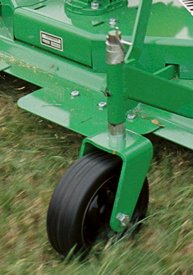 Follow ground contours
Follow ground contours

These rear-discharge mowers are equipped with four swivel wheels that follow ground contours and prevent scalping. Stamped, steel-reinforced wheel arms maintain a consistent cutting height.
iMatch™ quick-hitch conversion kits for grooming mowers
 iMatch quick-hitch
iMatch quick-hitch
One of the greatest concerns for operators involves difficulty in attaching tractor implements. John Deere has addressed this issue with the iMatch quick-hitch sytem.
The iMatch quick-hitch provides easy hookup and a guaranteed fit for all Category 1 implements designed to meet the ASAE Category 1 Standard S278.6 for quick-attach hitches.
All implements require a set of bushings in order for the attachment to fit and work properly with the iMatch quick-hitch. One set of bushings comes with the iMatch quick-hitch. Additional bushings are available from a John Deere dealer.
Mulching kits for grooming mowers
 Kit includes baffles, blades, and guard supports
Kit includes baffles, blades, and guard supports

A mulching kit is available as an attachment for field conversion. The mulching kit includes unique mulching blades, baffles, and guard supports to produce smaller clippings, which decompose faster than clippings that haven't been mulched.
Operators should follow the one-third rule for cutting height when mulching in grass.
This mulching kit also does an excellent job when mulching leaves.
Anti-scalping roller conversion kits for GM10E, GM11, and GM20 Series Grooming Mowers
 Anti-scalping roller attaches to front of deck
Anti-scalping roller attaches to front of deck

An anti-scalping roller kit can be ordered as an attachment for field conversion for FM and GM Series Grooming Mowers when it is not standard equipment. The roller is attached to the front of the cutting deck to help reduce scalping.
Each kit contains one roller.
Features
Floating top hitch
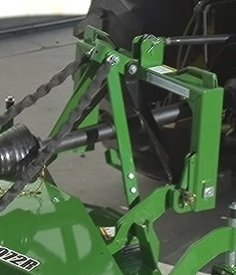 Provides a better cut
Provides a better cut

Floating hitches flex to allow the mower to better follow the terrain with less stress and wear to the tractor drawbar.
Rugged gearboxes with cooling fins
 Cooling fins extend the life of the gearbox
Cooling fins extend the life of the gearbox

The GM10 Series Standard-Duty Grooming Mowers come with a 29.8-kW (40-hp) rugged gearbox. Cooling fins help extend the life of the gearbox.
Choose from various cutting blades
 Three blades per deck
Three blades per deck

To meet specific mowing needs, choose from four blade types:
- Standard
- Mulching
- High lift
- Flat
iMatch™ quick-hitch conversion kits for grooming mowers
 iMatch quick-hitch
iMatch quick-hitch
One of the greatest concerns for operators involves difficulty in attaching tractor implements. John Deere has addressed this issue with the iMatch quick-hitch sytem.
The iMatch quick-hitch provides easy hookup and a guaranteed fit for all Category 1 implements designed to meet the ASAE Category 1 Standard S278.6 for quick-attach hitches.
All implements require a set of bushings in order for the attachment to fit and work properly with the iMatch quick-hitch. One set of bushings comes with the iMatch quick-hitch. Additional bushings are available from a John Deere dealer.
Anti-scalping front roller conversion kits for GM10, GM30, and FM10 Series Grooming Mowers
An anti-scalping front roller kit can be ordered as an attachment for field conversion for FM and GM Series Grooming Mowers when not standard equipment. The roller is attached to the front of the cutting deck to help reduce scalping.
Each kit contains one roller.
Rear chain shield conversion kit for grooming mowers
 Prevents debris from flying out from under deck
Prevents debris from flying out from under deck

A rear chain shield kit is available as an attachment for field conversion. It assists in preventing debris from flying out from underneath the deck of the rear-discharge grooming mowers.
Features
What is the best cutter for your job?
NOTE: Only for E, M, and R flex-wing models.
John Deere flex-wing rotary cutters lead the way with innovative design, superior durability, and proven performance. Valuable features are included such as a dome-shaped smooth deck, which prevent water and debris from accumulating on the top of the machine and makes it easy to clean up.
Built with a superior structural design that will satisfy different applications and segment desires, the single deck on the flex-wing cutters adds volume on the cutting chamber, allowing the machine to process more material and translating into an improvement in cut quality. The cutting chamber design allows the material to flow through the area and be discharged evenly throughout the width of the machine.
To help promote safe operation, John Deere rotary cutters are equipped with front and rear safety-chain shields and lighting kits to comply with U.S. regulations. John Deere rotary cutters continue to advance in value with larger, more powerful gearboxes, and updated constant-velocity (CV) drivelines.
Here are situations when a rotary cutter provides value:
- Clipping pastures encourages grass growth, optimizing on valuable pasture acreage.
- Cutting grass and stalks helps control insects.
- Routine cutting keeps weeds from reseeding.
- It is the most cost efficient way to cut roadsides, parks, cemeteries, airport fields, hydro, gas, and telephone easements, and all other types of open properties.
- Cutting grass waterways encourages root development and helps prevent erosion.
- Knocking down stalks such as cotton, corn, or milo speeds up decomposition. This is essential in no-till and minimum-till fields.
- Clearing out brush is easy.
- Control undergrowth and grass in orchards, vineyards, and groves.
Decide what model to use based on:
- The size of the area to mow versus the size of the machine – the bigger the area to mow, the bigger the mower needs to be in order to be efficient during mowing hours.
- The amount of time and frequency it will be used – for longer hours and more frequency, choose a heavier duty machine.
- Tractor compatibility – if there is a tractor the operator will be using, look for the tractor compatibility sheet to identify appropriate options.
- Choose the right features to satisfy specific needs – check out the value and benefits for each option to determine which one is the best fit for the work
John Deere flex-wing rotary cutters are available in three duty-level categories and four width sizes.
- E-spec
- Sizes: 3.7-m (12-ft) and 4.6-m (15-ft)
- E-spec models cut brush up to 50.8 mm (2 in.) in diameter
- Two tire options to choose from
- Available in 540 rpm
- Tractor compatibility – see chart
- Great choice for the property owners with light-duty applications
- M-spec
- Sizes: 4.6-m (15-ft) and 6.1-m (20-ft)
- M-spec models cut brush up to 76.2 mm (3 in.) in diameter
- Includes additional options to satisfy most customer needs
- Available in 540 or 1000 rpm
- Good match for medium-duty customers and their versatile jobs
- R-spec
- Sizes: 3.05-m (10-ft), 4.6-m (15-ft), and 6.1-m (20-ft)
- R-spec models cut brush up to 101.6 mm (4 in.) in diameter
- Available in 540 or 1000 rpm (R10 only available in 540 rpm)
- Excellent for road side mowing and more demanding applications
Safety
John Deere flex-wing rotary cutters are equipped with chains and lights as standard in all models.
Front and rear safety chains
 Front safety chains
Front safety chains
Chain shields offer protection to the operator and the area surrounding the cutter, yet allows uncut material to pass into the cutting chamber with minimal restriction.
 Optional double-row chains for R-spec models
Optional double-row chains for R-spec models
Lighting kit
 Lighting kit
Lighting kit
Lights are required for U.S. regulations on implements wider than 3.05 m (10 ft). All cutters come standard from the factory with lights.
Transport lock
 Transport lock on back axle
Transport lock on back axle
 Transport lock on wings
Transport lock on wings
Always use the transport lock on the wings and back axle while transporting or moving the machine.
Warranty
Five-year limited gearbox warranty provided on every John Deere rotary cutter
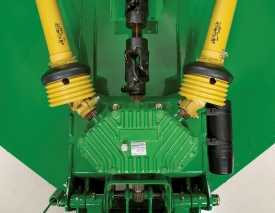 Five-year warranty on all flex-wing gearboxes
Five-year warranty on all flex-wing gearboxes
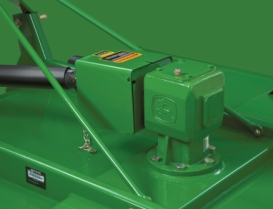 Five-year warranty on all rotary cutter gearboxes
Five-year warranty on all rotary cutter gearboxes
John Deere is so confident in the reliability of the gearbox that rotary cutters come with a 5-year limited gearbox warranty.
There is also 1-year warranty on the complete machine, as well as drivelines and other components.
Maintenance
John Deere flex-wing rotary cutters are equipped with a single dome deck to allow material debris and water to be easily removed from the top of the machine.
 Dome shape – clean top deck
Dome shape – clean top deck
R-spec machines
R-spec machines come standard with these features that will reduce overall maintenance time.
Maintenance-free bushings
 Sealed hinges
Sealed hinges
There is no need for greasing, as the machine includes internal pre-greased bushings and sealed hinges.
Back torsional suspension
 Torsional suspension
Torsional suspension
This requires minimal maintenance; operators only need to check that bolts are tightened every 40 hours.
Features
What is the best cutter for your job?
NOTE: Only for E, M, and R flex-wing models.
John Deere flex-wing rotary cutters lead the way with innovative design, superior durability, and proven performance. Valuable features are included such as a dome-shaped smooth deck, which prevent water and debris from accumulating on the top of the machine and makes it easy to clean up.
Built with a superior structural design that will satisfy different applications and segment desires, the single deck on the flex-wing cutters adds volume on the cutting chamber, allowing the machine to process more material and translating into an improvement in cut quality. The cutting chamber design allows the material to flow through the area and be discharged evenly throughout the width of the machine.
To help promote safe operation, John Deere rotary cutters are equipped with front and rear safety-chain shields and lighting kits to comply with U.S. regulations. John Deere rotary cutters continue to advance in value with larger, more powerful gearboxes, and updated constant-velocity (CV) drivelines.
Here are situations when a rotary cutter provides value:
- Clipping pastures encourages grass growth, optimizing on valuable pasture acreage.
- Cutting grass and stalks helps control insects.
- Routine cutting keeps weeds from reseeding.
- It is the most cost efficient way to cut roadsides, parks, cemeteries, airport fields, hydro, gas, and telephone easements, and all other types of open properties.
- Cutting grass waterways encourages root development and helps prevent erosion.
- Knocking down stalks such as cotton, corn, or milo speeds up decomposition. This is essential in no-till and minimum-till fields.
- Clearing out brush is easy.
- Control undergrowth and grass in orchards, vineyards, and groves.
Decide what model to use based on:
- The size of the area to mow versus the size of the machine – the bigger the area to mow, the bigger the mower needs to be in order to be efficient during mowing hours.
- The amount of time and frequency it will be used – for longer hours and more frequency, choose a heavier duty machine.
- Tractor compatibility – if there is a tractor the operator will be using, look for the tractor compatibility sheet to identify appropriate options.
- Choose the right features to satisfy specific needs – check out the value and benefits for each option to determine which one is the best fit for the work
John Deere flex-wing rotary cutters are available in three duty-level categories and four width sizes.
- E-spec
- Sizes: 3.7-m (12-ft) and 4.6-m (15-ft)
- E-spec models cut brush up to 50.8 mm (2 in.) in diameter
- Two tire options to choose from
- Available in 540 rpm
- Tractor compatibility – see chart
- Great choice for the property owners with light-duty applications
- M-spec
- Sizes: 4.6-m (15-ft) and 6.1-m (20-ft)
- M-spec models cut brush up to 76.2 mm (3 in.) in diameter
- Includes additional options to satisfy most customer needs
- Available in 540 or 1000 rpm
- Good match for medium-duty customers and their versatile jobs
- R-spec
- Sizes: 3.05-m (10-ft), 4.6-m (15-ft), and 6.1-m (20-ft)
- R-spec models cut brush up to 101.6 mm (4 in.) in diameter
- Available in 540 or 1000 rpm (R10 only available in 540 rpm)
- Excellent for road side mowing and more demanding applications
Safety
John Deere flex-wing rotary cutters are equipped with chains and lights as standard in all models.
Front and rear safety chains
 Front safety chains
Front safety chains
Chain shields offer protection to the operator and the area surrounding the cutter, yet allows uncut material to pass into the cutting chamber with minimal restriction.
 Optional double-row chains for R-spec models
Optional double-row chains for R-spec models
Lighting kit
 Lighting kit
Lighting kit
Lights are required for U.S. regulations on implements wider than 3.05 m (10 ft). All cutters come standard from the factory with lights.
Transport lock
 Transport lock on back axle
Transport lock on back axle
 Transport lock on wings
Transport lock on wings
Always use the transport lock on the wings and back axle while transporting or moving the machine.
Warranty
Five-year limited gearbox warranty provided on every John Deere rotary cutter
 Five-year warranty on all flex-wing gearboxes
Five-year warranty on all flex-wing gearboxes
 Five-year warranty on all rotary cutter gearboxes
Five-year warranty on all rotary cutter gearboxes
John Deere is so confident in the reliability of the gearbox that rotary cutters come with a 5-year limited gearbox warranty.
There is also 1-year warranty on the complete machine, as well as drivelines and other components.
Maintenance
John Deere flex-wing rotary cutters are equipped with a single dome deck to allow material debris and water to be easily removed from the top of the machine.
 Dome shape – clean top deck
Dome shape – clean top deck
R-spec machines
R-spec machines come standard with these features that will reduce overall maintenance time.
Maintenance-free bushings
 Sealed hinges
Sealed hinges
There is no need for greasing, as the machine includes internal pre-greased bushings and sealed hinges.
Back torsional suspension
 Torsional suspension
Torsional suspension
This requires minimal maintenance; operators only need to check that bolts are tightened every 40 hours.
Features
What is the best cutter for your job?
NOTE: Only for E, M, and R flex-wing models.
John Deere flex-wing rotary cutters lead the way with innovative design, superior durability, and proven performance. Valuable features are included such as a dome-shaped smooth deck, which prevent water and debris from accumulating on the top of the machine and makes it easy to clean up.
Built with a superior structural design that will satisfy different applications and segment desires, the single deck on the flex-wing cutters adds volume on the cutting chamber, allowing the machine to process more material and translating into an improvement in cut quality. The cutting chamber design allows the material to flow through the area and be discharged evenly throughout the width of the machine.
To help promote safe operation, John Deere rotary cutters are equipped with front and rear safety-chain shields and lighting kits to comply with U.S. regulations. John Deere rotary cutters continue to advance in value with larger, more powerful gearboxes, and updated constant-velocity (CV) drivelines.
Here are situations when a rotary cutter provides value:
- Clipping pastures encourages grass growth, optimizing on valuable pasture acreage.
- Cutting grass and stalks helps control insects.
- Routine cutting keeps weeds from reseeding.
- It is the most cost efficient way to cut roadsides, parks, cemeteries, airport fields, hydro, gas, and telephone easements, and all other types of open properties.
- Cutting grass waterways encourages root development and helps prevent erosion.
- Knocking down stalks such as cotton, corn, or milo speeds up decomposition. This is essential in no-till and minimum-till fields.
- Clearing out brush is easy.
- Control undergrowth and grass in orchards, vineyards, and groves.
Decide what model to use based on:
- The size of the area to mow versus the size of the machine – the bigger the area to mow, the bigger the mower needs to be in order to be efficient during mowing hours.
- The amount of time and frequency it will be used – for longer hours and more frequency, choose a heavier duty machine.
- Tractor compatibility – if there is a tractor the operator will be using, look for the tractor compatibility sheet to identify appropriate options.
- Choose the right features to satisfy specific needs – check out the value and benefits for each option to determine which one is the best fit for the work
John Deere flex-wing rotary cutters are available in three duty-level categories and four width sizes.
- E-spec
- Sizes: 3.7-m (12-ft) and 4.6-m (15-ft)
- E-spec models cut brush up to 50.8 mm (2 in.) in diameter
- Two tire options to choose from
- Available in 540 rpm
- Tractor compatibility – see chart
- Great choice for the property owners with light-duty applications
- M-spec
- Sizes: 4.6-m (15-ft) and 6.1-m (20-ft)
- M-spec models cut brush up to 76.2 mm (3 in.) in diameter
- Includes additional options to satisfy most customer needs
- Available in 540 or 1000 rpm
- Good match for medium-duty customers and their versatile jobs
- R-spec
- Sizes: 3.05-m (10-ft), 4.6-m (15-ft), and 6.1-m (20-ft)
- R-spec models cut brush up to 101.6 mm (4 in.) in diameter
- Available in 540 or 1000 rpm (R10 only available in 540 rpm)
- Excellent for road side mowing and more demanding applications
Safety
John Deere flex-wing rotary cutters are equipped with chains and lights as standard in all models.
Front and rear safety chains
 Front safety chains
Front safety chains
Chain shields offer protection to the operator and the area surrounding the cutter, yet allows uncut material to pass into the cutting chamber with minimal restriction.
 Optional double-row chains for R-spec models
Optional double-row chains for R-spec models
Lighting kit
 Lighting kit
Lighting kit
Lights are required for U.S. regulations on implements wider than 3.05 m (10 ft). All cutters come standard from the factory with lights.
Transport lock
 Transport lock on back axle
Transport lock on back axle
 Transport lock on wings
Transport lock on wings
Always use the transport lock on the wings and back axle while transporting or moving the machine.
Warranty
Five-year limited gearbox warranty provided on every John Deere rotary cutter
 Five-year warranty on all flex-wing gearboxes
Five-year warranty on all flex-wing gearboxes
 Five-year warranty on all rotary cutter gearboxes
Five-year warranty on all rotary cutter gearboxes
John Deere is so confident in the reliability of the gearbox that rotary cutters come with a 5-year limited gearbox warranty.
There is also 1-year warranty on the complete machine, as well as drivelines and other components.
Maintenance
John Deere flex-wing rotary cutters are equipped with a single dome deck to allow material debris and water to be easily removed from the top of the machine.
 Dome shape – clean top deck
Dome shape – clean top deck
R-spec machines
R-spec machines come standard with these features that will reduce overall maintenance time.
Maintenance-free bushings
 Sealed hinges
Sealed hinges
There is no need for greasing, as the machine includes internal pre-greased bushings and sealed hinges.
Back torsional suspension
 Torsional suspension
Torsional suspension
This requires minimal maintenance; operators only need to check that bolts are tightened every 40 hours.
Features
What is the best cutter for your job?
NOTE: Only for E, M, and R flex-wing models.
John Deere flex-wing rotary cutters lead the way with innovative design, superior durability, and proven performance. Valuable features are included such as a dome-shaped smooth deck, which prevent water and debris from accumulating on the top of the machine and makes it easy to clean up.
Built with a superior structural design that will satisfy different applications and segment desires, the single deck on the flex-wing cutters adds volume on the cutting chamber, allowing the machine to process more material and translating into an improvement in cut quality. The cutting chamber design allows the material to flow through the area and be discharged evenly throughout the width of the machine.
To help promote safe operation, John Deere rotary cutters are equipped with front and rear safety-chain shields and lighting kits to comply with U.S. regulations. John Deere rotary cutters continue to advance in value with larger, more powerful gearboxes, and updated constant-velocity (CV) drivelines.
Here are situations when a rotary cutter provides value:
- Clipping pastures encourages grass growth, optimizing on valuable pasture acreage.
- Cutting grass and stalks helps control insects.
- Routine cutting keeps weeds from reseeding.
- It is the most cost efficient way to cut roadsides, parks, cemeteries, airport fields, hydro, gas, and telephone easements, and all other types of open properties.
- Cutting grass waterways encourages root development and helps prevent erosion.
- Knocking down stalks such as cotton, corn, or milo speeds up decomposition. This is essential in no-till and minimum-till fields.
- Clearing out brush is easy.
- Control undergrowth and grass in orchards, vineyards, and groves.
Decide what model to use based on:
- The size of the area to mow versus the size of the machine – the bigger the area to mow, the bigger the mower needs to be in order to be efficient during mowing hours.
- The amount of time and frequency it will be used – for longer hours and more frequency, choose a heavier duty machine.
- Tractor compatibility – if there is a tractor the operator will be using, look for the tractor compatibility sheet to identify appropriate options.
- Choose the right features to satisfy specific needs – check out the value and benefits for each option to determine which one is the best fit for the work
John Deere flex-wing rotary cutters are available in three duty-level categories and four width sizes.
- E-spec
- Sizes: 3.7-m (12-ft) and 4.6-m (15-ft)
- E-spec models cut brush up to 50.8 mm (2 in.) in diameter
- Two tire options to choose from
- Available in 540 rpm
- Tractor compatibility – see chart
- Great choice for the property owners with light-duty applications
- M-spec
- Sizes: 4.6-m (15-ft) and 6.1-m (20-ft)
- M-spec models cut brush up to 76.2 mm (3 in.) in diameter
- Includes additional options to satisfy most customer needs
- Available in 540 or 1000 rpm
- Good match for medium-duty customers and their versatile jobs
- R-spec
- Sizes: 3.05-m (10-ft), 4.6-m (15-ft), and 6.1-m (20-ft)
- R-spec models cut brush up to 101.6 mm (4 in.) in diameter
- Available in 540 or 1000 rpm (R10 only available in 540 rpm)
- Excellent for road side mowing and more demanding applications
Safety
John Deere flex-wing rotary cutters are equipped with chains and lights as standard in all models.
Front and rear safety chains
 Front safety chains
Front safety chains
Chain shields offer protection to the operator and the area surrounding the cutter, yet allows uncut material to pass into the cutting chamber with minimal restriction.
 Optional double-row chains for R-spec models
Optional double-row chains for R-spec models
Lighting kit
 Lighting kit
Lighting kit
Lights are required for U.S. regulations on implements wider than 3.05 m (10 ft). All cutters come standard from the factory with lights.
Transport lock
 Transport lock on back axle
Transport lock on back axle
 Transport lock on wings
Transport lock on wings
Always use the transport lock on the wings and back axle while transporting or moving the machine.
Warranty
Five-year limited gearbox warranty provided on every John Deere rotary cutter
 Five-year warranty on all flex-wing gearboxes
Five-year warranty on all flex-wing gearboxes
 Five-year warranty on all rotary cutter gearboxes
Five-year warranty on all rotary cutter gearboxes
John Deere is so confident in the reliability of the gearbox that rotary cutters come with a 5-year limited gearbox warranty.
There is also 1-year warranty on the complete machine, as well as drivelines and other components.
Maintenance
John Deere flex-wing rotary cutters are equipped with a single dome deck to allow material debris and water to be easily removed from the top of the machine.
 Dome shape – clean top deck
Dome shape – clean top deck
R-spec machines
R-spec machines come standard with these features that will reduce overall maintenance time.
Maintenance-free bushings
 Sealed hinges
Sealed hinges
There is no need for greasing, as the machine includes internal pre-greased bushings and sealed hinges.
Back torsional suspension
 Torsional suspension
Torsional suspension
This requires minimal maintenance; operators only need to check that bolts are tightened every 40 hours.
Features
What is the best cutter for your job?
NOTE: Only for E, M, and R flex-wing models.
John Deere flex-wing rotary cutters lead the way with innovative design, superior durability, and proven performance. Valuable features are included such as a dome-shaped smooth deck, which prevent water and debris from accumulating on the top of the machine and makes it easy to clean up.
Built with a superior structural design that will satisfy different applications and segment desires, the single deck on the flex-wing cutters adds volume on the cutting chamber, allowing the machine to process more material and translating into an improvement in cut quality. The cutting chamber design allows the material to flow through the area and be discharged evenly throughout the width of the machine.
To help promote safe operation, John Deere rotary cutters are equipped with front and rear safety-chain shields and lighting kits to comply with U.S. regulations. John Deere rotary cutters continue to advance in value with larger, more powerful gearboxes, and updated constant-velocity (CV) drivelines.
Here are situations when a rotary cutter provides value:
- Clipping pastures encourages grass growth, optimizing on valuable pasture acreage.
- Cutting grass and stalks helps control insects.
- Routine cutting keeps weeds from reseeding.
- It is the most cost efficient way to cut roadsides, parks, cemeteries, airport fields, hydro, gas, and telephone easements, and all other types of open properties.
- Cutting grass waterways encourages root development and helps prevent erosion.
- Knocking down stalks such as cotton, corn, or milo speeds up decomposition. This is essential in no-till and minimum-till fields.
- Clearing out brush is easy.
- Control undergrowth and grass in orchards, vineyards, and groves.
Decide what model to use based on:
- The size of the area to mow versus the size of the machine – the bigger the area to mow, the bigger the mower needs to be in order to be efficient during mowing hours.
- The amount of time and frequency it will be used – for longer hours and more frequency, choose a heavier duty machine.
- Tractor compatibility – if there is a tractor the operator will be using, look for the tractor compatibility sheet to identify appropriate options.
- Choose the right features to satisfy specific needs – check out the value and benefits for each option to determine which one is the best fit for the work
John Deere flex-wing rotary cutters are available in three duty-level categories and four width sizes.
- E-spec
- Sizes: 3.7-m (12-ft) and 4.6-m (15-ft)
- E-spec models cut brush up to 50.8 mm (2 in.) in diameter
- Two tire options to choose from
- Available in 540 rpm
- Tractor compatibility – see chart
- Great choice for the property owners with light-duty applications
- M-spec
- Sizes: 4.6-m (15-ft) and 6.1-m (20-ft)
- M-spec models cut brush up to 76.2 mm (3 in.) in diameter
- Includes additional options to satisfy most customer needs
- Available in 540 or 1000 rpm
- Good match for medium-duty customers and their versatile jobs
- R-spec
- Sizes: 3.05-m (10-ft), 4.6-m (15-ft), and 6.1-m (20-ft)
- R-spec models cut brush up to 101.6 mm (4 in.) in diameter
- Available in 540 or 1000 rpm (R10 only available in 540 rpm)
- Excellent for road side mowing and more demanding applications
Safety
John Deere flex-wing rotary cutters are equipped with chains and lights as standard in all models.
Front and rear safety chains
 Front safety chains
Front safety chains
Chain shields offer protection to the operator and the area surrounding the cutter, yet allows uncut material to pass into the cutting chamber with minimal restriction.
 Optional double-row chains for R-spec models
Optional double-row chains for R-spec models
Lighting kit
 Lighting kit
Lighting kit
Lights are required for U.S. regulations on implements wider than 3.05 m (10 ft). All cutters come standard from the factory with lights.
Transport lock
 Transport lock on back axle
Transport lock on back axle
 Transport lock on wings
Transport lock on wings
Always use the transport lock on the wings and back axle while transporting or moving the machine.
Warranty
Five-year limited gearbox warranty provided on every John Deere rotary cutter
 Five-year warranty on all flex-wing gearboxes
Five-year warranty on all flex-wing gearboxes
 Five-year warranty on all rotary cutter gearboxes
Five-year warranty on all rotary cutter gearboxes
John Deere is so confident in the reliability of the gearbox that rotary cutters come with a 5-year limited gearbox warranty.
There is also 1-year warranty on the complete machine, as well as drivelines and other components.
Maintenance
John Deere flex-wing rotary cutters are equipped with a single dome deck to allow material debris and water to be easily removed from the top of the machine.
 Dome shape – clean top deck
Dome shape – clean top deck
R-spec machines
R-spec machines come standard with these features that will reduce overall maintenance time.
Maintenance-free bushings
 Sealed hinges
Sealed hinges
There is no need for greasing, as the machine includes internal pre-greased bushings and sealed hinges.
Back torsional suspension
 Torsional suspension
Torsional suspension
This requires minimal maintenance; operators only need to check that bolts are tightened every 40 hours.
Features
What is the best cutter for your job?
NOTE: Only for E, M, and R flex-wing models.
John Deere flex-wing rotary cutters lead the way with innovative design, superior durability, and proven performance. Valuable features are included such as a dome-shaped smooth deck, which prevent water and debris from accumulating on the top of the machine and makes it easy to clean up.
Built with a superior structural design that will satisfy different applications and segment desires, the single deck on the flex-wing cutters adds volume on the cutting chamber, allowing the machine to process more material and translating into an improvement in cut quality. The cutting chamber design allows the material to flow through the area and be discharged evenly throughout the width of the machine.
To help promote safe operation, John Deere rotary cutters are equipped with front and rear safety-chain shields and lighting kits to comply with U.S. regulations. John Deere rotary cutters continue to advance in value with larger, more powerful gearboxes, and updated constant-velocity (CV) drivelines.
Here are situations when a rotary cutter provides value:
- Clipping pastures encourages grass growth, optimizing on valuable pasture acreage.
- Cutting grass and stalks helps control insects.
- Routine cutting keeps weeds from reseeding.
- It is the most cost efficient way to cut roadsides, parks, cemeteries, airport fields, hydro, gas, and telephone easements, and all other types of open properties.
- Cutting grass waterways encourages root development and helps prevent erosion.
- Knocking down stalks such as cotton, corn, or milo speeds up decomposition. This is essential in no-till and minimum-till fields.
- Clearing out brush is easy.
- Control undergrowth and grass in orchards, vineyards, and groves.
Decide what model to use based on:
- The size of the area to mow versus the size of the machine – the bigger the area to mow, the bigger the mower needs to be in order to be efficient during mowing hours.
- The amount of time and frequency it will be used – for longer hours and more frequency, choose a heavier duty machine.
- Tractor compatibility – if there is a tractor the operator will be using, look for the tractor compatibility sheet to identify appropriate options.
- Choose the right features to satisfy specific needs – check out the value and benefits for each option to determine which one is the best fit for the work
John Deere flex-wing rotary cutters are available in three duty-level categories and four width sizes.
- E-spec
- Sizes: 3.7-m (12-ft) and 4.6-m (15-ft)
- E-spec models cut brush up to 50.8 mm (2 in.) in diameter
- Two tire options to choose from
- Available in 540 rpm
- Tractor compatibility – see chart
- Great choice for the property owners with light-duty applications
- M-spec
- Sizes: 4.6-m (15-ft) and 6.1-m (20-ft)
- M-spec models cut brush up to 76.2 mm (3 in.) in diameter
- Includes additional options to satisfy most customer needs
- Available in 540 or 1000 rpm
- Good match for medium-duty customers and their versatile jobs
- R-spec
- Sizes: 3.05-m (10-ft), 4.6-m (15-ft), and 6.1-m (20-ft)
- R-spec models cut brush up to 101.6 mm (4 in.) in diameter
- Available in 540 or 1000 rpm (R10 only available in 540 rpm)
- Excellent for road side mowing and more demanding applications
Safety
John Deere flex-wing rotary cutters are equipped with chains and lights as standard in all models.
Front and rear safety chains
 Front safety chains
Front safety chains
Chain shields offer protection to the operator and the area surrounding the cutter, yet allows uncut material to pass into the cutting chamber with minimal restriction.
 Optional double-row chains for R-spec models
Optional double-row chains for R-spec models
Lighting kit
 Lighting kit
Lighting kit
Lights are required for U.S. regulations on implements wider than 3.05 m (10 ft). All cutters come standard from the factory with lights.
Transport lock
 Transport lock on back axle
Transport lock on back axle
 Transport lock on wings
Transport lock on wings
Always use the transport lock on the wings and back axle while transporting or moving the machine.
Warranty
Five-year limited gearbox warranty provided on every John Deere rotary cutter
 Five-year warranty on all flex-wing gearboxes
Five-year warranty on all flex-wing gearboxes
 Five-year warranty on all rotary cutter gearboxes
Five-year warranty on all rotary cutter gearboxes
John Deere is so confident in the reliability of the gearbox that rotary cutters come with a 5-year limited gearbox warranty.
There is also 1-year warranty on the complete machine, as well as drivelines and other components.
Maintenance
John Deere flex-wing rotary cutters are equipped with a single dome deck to allow material debris and water to be easily removed from the top of the machine.
 Dome shape – clean top deck
Dome shape – clean top deck
R-spec machines
R-spec machines come standard with these features that will reduce overall maintenance time.
Maintenance-free bushings
 Sealed hinges
Sealed hinges
There is no need for greasing, as the machine includes internal pre-greased bushings and sealed hinges.
Back torsional suspension
 Torsional suspension
Torsional suspension
This requires minimal maintenance; operators only need to check that bolts are tightened every 40 hours.
Features
What is the best cutter for your job?
NOTE: Only for E, M, and R flex-wing models.
John Deere flex-wing rotary cutters lead the way with innovative design, superior durability, and proven performance. Valuable features are included such as a dome-shaped smooth deck, which prevent water and debris from accumulating on the top of the machine and makes it easy to clean up.
Built with a superior structural design that will satisfy different applications and segment desires, the single deck on the flex-wing cutters adds volume on the cutting chamber, allowing the machine to process more material and translating into an improvement in cut quality. The cutting chamber design allows the material to flow through the area and be discharged evenly throughout the width of the machine.
To help promote safe operation, John Deere rotary cutters are equipped with front and rear safety-chain shields and lighting kits to comply with U.S. regulations. John Deere rotary cutters continue to advance in value with larger, more powerful gearboxes, and updated constant-velocity (CV) drivelines.
Here are situations when a rotary cutter provides value:
- Clipping pastures encourages grass growth, optimizing on valuable pasture acreage.
- Cutting grass and stalks helps control insects.
- Routine cutting keeps weeds from reseeding.
- It is the most cost efficient way to cut roadsides, parks, cemeteries, airport fields, hydro, gas, and telephone easements, and all other types of open properties.
- Cutting grass waterways encourages root development and helps prevent erosion.
- Knocking down stalks such as cotton, corn, or milo speeds up decomposition. This is essential in no-till and minimum-till fields.
- Clearing out brush is easy.
- Control undergrowth and grass in orchards, vineyards, and groves.
Decide what model to use based on:
- The size of the area to mow versus the size of the machine – the bigger the area to mow, the bigger the mower needs to be in order to be efficient during mowing hours.
- The amount of time and frequency it will be used – for longer hours and more frequency, choose a heavier duty machine.
- Tractor compatibility – if there is a tractor the operator will be using, look for the tractor compatibility sheet to identify appropriate options.
- Choose the right features to satisfy specific needs – check out the value and benefits for each option to determine which one is the best fit for the work
John Deere flex-wing rotary cutters are available in three duty-level categories and four width sizes.
- E-spec
- Sizes: 3.7-m (12-ft) and 4.6-m (15-ft)
- E-spec models cut brush up to 50.8 mm (2 in.) in diameter
- Two tire options to choose from
- Available in 540 rpm
- Tractor compatibility – see chart
- Great choice for the property owners with light-duty applications
- M-spec
- Sizes: 4.6-m (15-ft) and 6.1-m (20-ft)
- M-spec models cut brush up to 76.2 mm (3 in.) in diameter
- Includes additional options to satisfy most customer needs
- Available in 540 or 1000 rpm
- Good match for medium-duty customers and their versatile jobs
- R-spec
- Sizes: 3.05-m (10-ft), 4.6-m (15-ft), and 6.1-m (20-ft)
- R-spec models cut brush up to 101.6 mm (4 in.) in diameter
- Available in 540 or 1000 rpm (R10 only available in 540 rpm)
- Excellent for road side mowing and more demanding applications
Safety
John Deere flex-wing rotary cutters are equipped with chains and lights as standard in all models.
Front and rear safety chains
 Front safety chains
Front safety chains
Chain shields offer protection to the operator and the area surrounding the cutter, yet allows uncut material to pass into the cutting chamber with minimal restriction.
 Optional double-row chains for R-spec models
Optional double-row chains for R-spec models
Lighting kit
 Lighting kit
Lighting kit
Lights are required for U.S. regulations on implements wider than 3.05 m (10 ft). All cutters come standard from the factory with lights.
Transport lock
 Transport lock on back axle
Transport lock on back axle
 Transport lock on wings
Transport lock on wings
Always use the transport lock on the wings and back axle while transporting or moving the machine.
Warranty
Five-year limited gearbox warranty provided on every John Deere rotary cutter
 Five-year warranty on all flex-wing gearboxes
Five-year warranty on all flex-wing gearboxes
 Five-year warranty on all rotary cutter gearboxes
Five-year warranty on all rotary cutter gearboxes
John Deere is so confident in the reliability of the gearbox that rotary cutters come with a 5-year limited gearbox warranty.
There is also 1-year warranty on the complete machine, as well as drivelines and other components.
Maintenance
John Deere flex-wing rotary cutters are equipped with a single dome deck to allow material debris and water to be easily removed from the top of the machine.
 Dome shape – clean top deck
Dome shape – clean top deck
R-spec machines
R-spec machines come standard with these features that will reduce overall maintenance time.
Maintenance-free bushings
 Sealed hinges
Sealed hinges
There is no need for greasing, as the machine includes internal pre-greased bushings and sealed hinges.
Back torsional suspension
 Torsional suspension
Torsional suspension
This requires minimal maintenance; operators only need to check that bolts are tightened every 40 hours.
Features
Save time attaching or detaching the loader with the single-point hydraulic connection
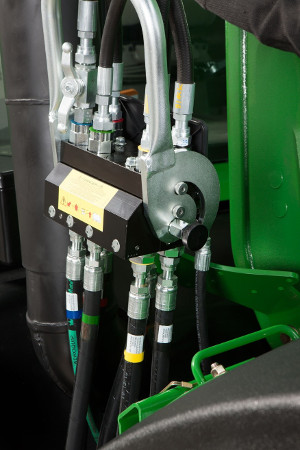 Single-point hydraulic connection
Single-point hydraulic connection
The 700M Loader features a single-point hydraulic connection that saves the operator time when attaching or detaching the loader. This feature also incorporates the connection point for any electrical needs as well as the hydraulic lockout valve. With all hydraulic and electrical connections in one location, installation is quickly completed with the push of a handle.
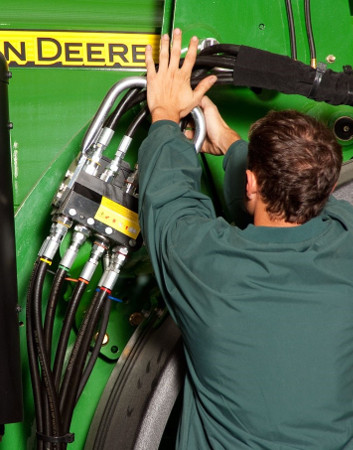 Single-point hydraulic installation
Single-point hydraulic installation
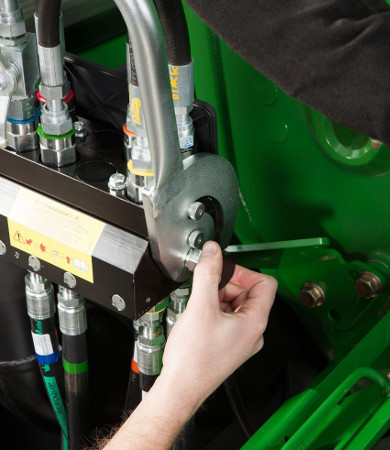 Pressure relief knob
Pressure relief knob
NOTE: Before disconnecting the hydraulic connection between the loader and the tractor, it is necessary to release the hydraulic pressure.
Improve appearance and reduce damage with concealed oil lines
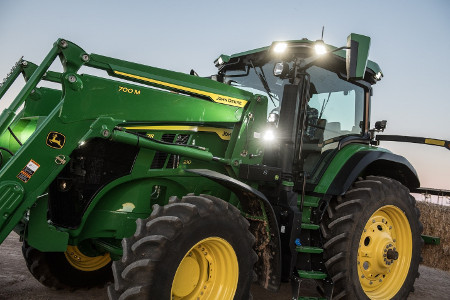 700M Loader with concealed oil lines on 7R 210 Tractor
700M Loader with concealed oil lines on 7R 210 Tractor
The 700M Loader has been redesigned to route the oil lines and hydraulic lines through the boom arm and the torque tube. This internal routing ensures better protection of the lines from external damage and improves the overall appearance of the loader.
Quick and easy loader removal and parking using toolless features
 700M Loader on 7R 210 Tractor
700M Loader on 7R 210 Tractor
John Deere loaders are quickly attached and detached from the tractor without the need for tools. With easy-to-use mast pins, parking stands, and single-point hydraulic connection, the loader can be removed and reinstalled in minutes. To work in applications outside of loader use, John Deere loaders provide an efficient solution to park the loader.
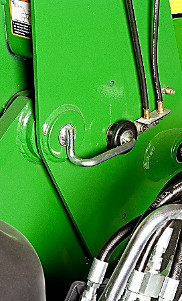 Loader mast pin
Loader mast pin
 Parking stand
Parking stand
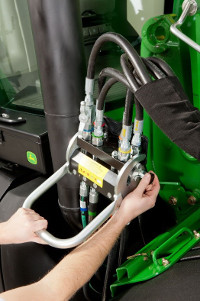 Single-point hydraulic connection
Single-point hydraulic connection
Removal and parking of the loader can be done with the following instructions:
- Apply slight down pressure to the loader boom with the bucket dumped at approximately a 30-degree angle.
- With the tractor in park, install the parking stands and place the mast pins in the open position.
- Utilizing the boom circuit with the tractor in neutral, rotate the mast forward until the mast has rotated past the pin location on the mounting frame by extending the lift cylinder. Using the bucket circuit, rollback the bucket until the mast is removed from the pocket and will clear the tires.
- With the tractor in park, shut the engine off and relieve the hydraulic pressure as indicated for the tractor. Relieve pressure on the single-point hydraulic connection, then disconnect or open the single-point hydraulic connector.
- Store the loader half of the single-point connector on the side of the loader boom. The tractor is now ready to back away from the loader.
Easy and safe service using the boom lockout function
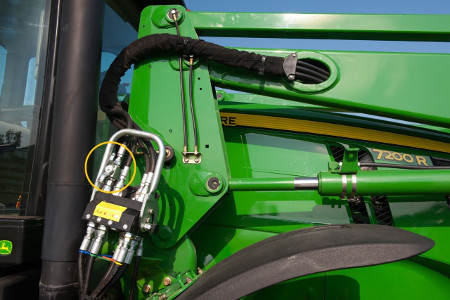 Hydraulic shut-off valve at single-point hydraulic connection
Hydraulic shut-off valve at single-point hydraulic connection
The 700M Loader comes equipped with a hydraulic shut-off valve to improve serviceability. When conducting brief service to the loader, close the hydraulic shut-off to ensure the loader does not move while operating under the equipment. This feature promotes a safe way to conduct brief maintenance without having to use support stands or removing the loader completely.
Faster cycle time for mechanical self-leveling (MSL) loaders using false rod cylinders
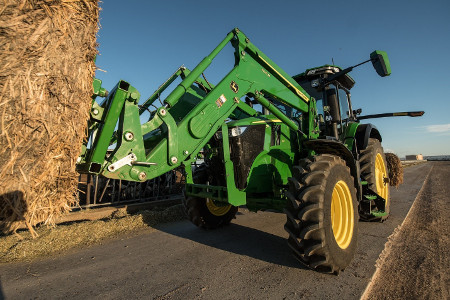 700M Loader working with 7R 210 Tractor
700M Loader working with 7R 210 Tractor
The mechanical self-leveling 700M Loader utilizes a false rod cylinder to improve cycle-time performance. This bucket cylinder is designed with a smaller displacement of oil required on the head end of the cylinder, which allows the cylinder to function more quickly, decreasing operation cycle time. With the false rod cylinder design, loader applications can work more quickly and efficiently.
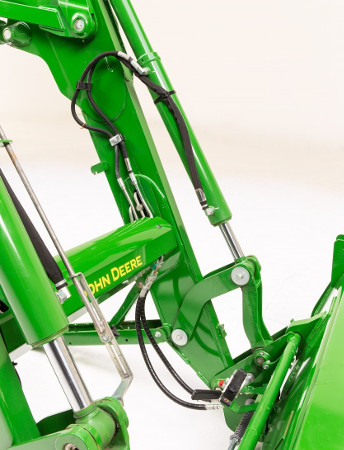 False rod cylinders on 600R Loader
False rod cylinders on 600R Loader
Features
Ideal tractor-loader combination with model year 2020 6110M and 6120M Tractor compatibility
Redesigned to improve compatibility
 6120M Tractor with 600R Loader
6120M Tractor with 600R Loader
The 600R Loader has been redesigned to work effortlessly with the model year 2020 6110M and 6120M Tractors. The 6110M and 6120M Tractors are equipped with a sloped hood to improve operator visibility. In cadence with this updated tractor design, the 600R Loader features curved booms, making an ideal tractor-loader combination. This combination also includes a 22.9-cm (9-in.) reduction in overall machine and loader length, improving forward visibility by over 2.1 m (7 ft). Pairing the model year 2020 6110M or 6120M Tractor with the 600R Loader allows visibility directly to the loader attachment, providing more efficient performance with any loader application.
Panoramic roof for increased visibility
 600R Loader through 6120M Tractor panoramic roof
600R Loader through 6120M Tractor panoramic roof
As the lift height of the R-Series Loaders increases, the panoramic roof inside of the 6M Tractor cab provides additional visibility to the entire lift-cycle of the loader. The 600R Loader has a lift height up to 391.2 cm (154 in.), allowing an operator to stack three bales. Through the larger panoramic roof of the 6M Tractor, tasks such as stacking bales can be done quickly and efficiently.
Light-emitting diode (LED) light option for variable operating conditions
 600R Loader on 6110M Tractor with LED light package
600R Loader on 6110M Tractor with LED light package
To further enhance visibility, the 600R Loader has the option to include LED lights. With LED lights mounted onto each side of the loader boom, performing loader applications in variable operating conditions is made easier. Pairing the loader LED light option with an LED light package on the 6110M or 6120M Tractor will provide unmatched visibility to enhance operator experience during any task.
Save time with single-point hydraulic connection
 Single-point hydraulic connection on the 600R Loader
Single-point hydraulic connection on the 600R Loader
The R-Series Loaders feature a single-point hydraulic connection that saves the operator time when attaching or detaching the loader. This feature also incorporates the connection point for any electrical needs as well as the hydraulic lockout valve. With all hydraulic and electrical connections in one location, installation is quickly completed with the pull of a handle.
NOTE: Before disconnecting the hydraulic connection between the loader and the tractor, it is necessary to release the hydraulic pressure.
 Single-point hydraulic connection (open)
Single-point hydraulic connection (open)
 Single-point hydraulic connection (closed)
Single-point hydraulic connection (closed)
Improve appearance and reduce damage with concealed oil lines
 600R Loader with concealed oil lines
600R Loader with concealed oil lines

The R-Series Loaders have been redesigned to route the oil lines and hydraulic lines through the boom arm and the torque tube. This internal routing ensures better protection of the lines from external damage and improves the overall appearance of the loader.
 600R Loader (side view)
600R Loader (side view)
 600R Loader (angle view)
600R Loader (angle view)
Easy loader removal using automatic mast latch
 Rear view of 600R Loader
Rear view of 600R Loader
R-Series Loaders are even easier to attach and detach due to the automatic mast latch system. This feature provides efficiency to operations that require frequent loader parking. The automatic mast latch system is a mechanical lever that allows operators to remove or attach the loader with one trip out of the cab. The ease and convenience provided by the automatic mast latch system provides improvement to operation uptime.
 Automatic mast latch lever
Automatic mast latch lever
 Visual lock/unlock indicator
Visual lock/unlock indicator
Easy service with boom lockout
 Hydraulic shut-off valve on R-Series Loader
Hydraulic shut-off valve on R-Series Loader
The R-Series Loaders come equipped with a hydraulic shut-off valve to improve servicabiity. When conducting brief service to the loader, close the hydraulic shut-off valve to ensure the loader does not move while operating under the equipment. This feature promotes a safe way to conduct brief maintenance without having to use support stands or removing the loader completely.
Faster cycle time for mechanical self-leveling (MSL) Loaders using false rod cylinders
 600R Loader working with 6120M Tractor
600R Loader working with 6120M Tractor

The MSL R-Series Loaders utilize a false rod cylinder to improve bucket performance. This bucket cylinder is designed with a smaller displacement of oil required on the head end of the cylinder, which allows the cylinder to function more quickly, decreasing operation cycle time. With the false rod cylinder design, loader applications can work more quickly and efficiently.
 False rod cylinders on 600R Loader
False rod cylinders on 600R Loader
Further improve productivity with loader options
 600R Loader on a 6120M Tractor
600R Loader on a 6120M Tractor
The R-Series Loaders provide several options to enhance operator experience and productivity in the field. Individual options can be ordered to fit an operation’s unique set of needs. Some of the available loader options include:
- Loader lights for enhanced visibility
- Hydraulic remote implement latch improves uptime
- Return-to-Position (RTP) Gen 2 with electronic self-leveling (ESL)
- Loader suspension system for a smoother ride
Loader lights for enhanced visibility
 600R Loader with light-emitting diode (LED) lights
600R Loader with light-emitting diode (LED) lights
To further enhance visibility, the 600R Loader has the option to include LED lights. With LED lights mounted onto each side of the loader boom, performing loader applications in variable operating conditions is made easier. Pairing the loader LED light option with an LED light package on the 6110M or 6120M Tractor will provide unmatched visibility to enhance operator experience during any task.
Hydraulic remote implement latch improves uptime
 Two-button activation for hydraulic remote implement latch
Two-button activation for hydraulic remote implement latch
The hydraulic remote implement latch allows implements to be changed quickly and efficiently. An operator can activate the device from the cab by simultaneously pressing the two buttons installed on the right-hand side of the operator’s station. Switching from one attachment to the next can now be accomplished quickly with limited movements of the loader and without leaving the operator’s seat.
Return-to-Position (RTP) Gen 2 with electronic self-leveling (ESL)
 Electronic loader joystick
Electronic loader joystick
The second generation of industry-exclusive RTP Gen 2 with ESL provides a practical solution for operators with daily, repetitive, material handling needs. RTP allows the operator to set different position points for the loader with the flick of the wrist, activating the detent in electronic joysticks. With the second generation of RTP, operators can set application profiles rather than entering position points each time an application is in use. RTP Gen 2 with ESL removes repetition and fatigue from loader applications.
Loader suspension system for a smoother ride
 600R Loader working with a 5100R Tractor
600R Loader working with a 5100R Tractor
The loader suspension system improves operator comfort and loader efficiency during loader operation. This system is easily activated by the operator from the cab. When activated, the loader suspension system absorbs the shock providing a smoother ride in the cab as well as reducing material loss from the bucket.
Features
Superior comfort and enhanced operation with cab updates
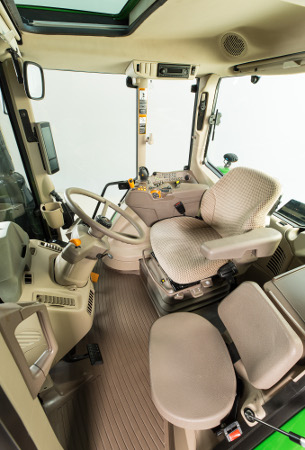 6120M standard cab with Compact CommandARM™ console
6120M standard cab with Compact CommandARM™ console
The 6M Tractor was designed to ensure maximum maneuverability, visibility, and superior comfort for operators’ working long days. The 6110M and 6120M, with the updated sloped-down hood design, feature a 17.8-cm (7-in.) shorter wheelbase (240 cm [94.5 in.]) allowing you to maneuver tight areas with no problems. Inside, the 6M cab has been designed to maximize operator comfort and visibility. All-around visibility of 310 degrees from within the cab ensures accurate tractor placement, implement hookup, and optimum tractor performance. Additionally, all 6M Tractors will come standard with a digital cornerpost display and include additional options to further improve operator satisfaction like:
- Mechanical or electrical joystick with PowrReverser™ functionality
- Quickly and easily change directions with the push of a button while doing loader work
- Compact CommandARM console
- Swivel in your seat and have all the controls at your fingertips
- Front axle suspension
- Panoramic roof
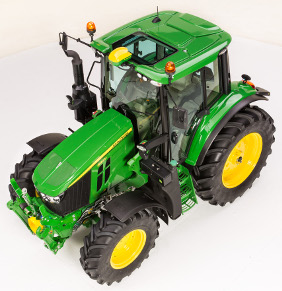 Panoramic roof
Panoramic roof
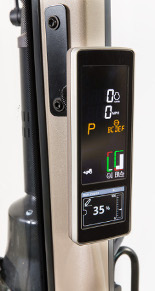 Cornerpost display
Cornerpost display
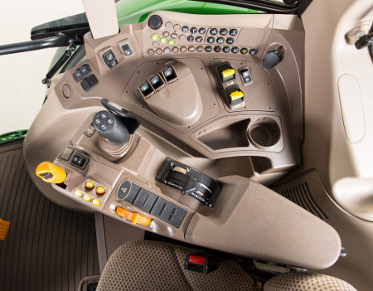 Compact CommandARM
Compact CommandARM
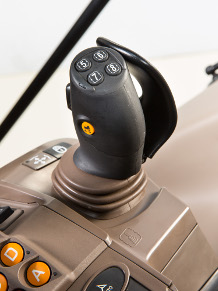 PowrReverser
PowrReverser
Boost power and productivity in operations using Intelligent Power Management
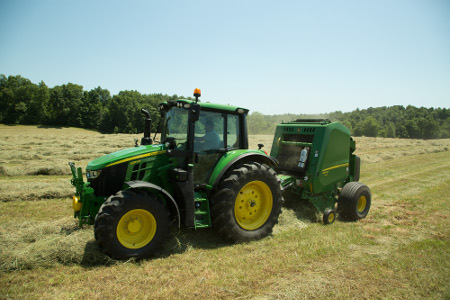 6120M with Intelligent Power Management
6120M with Intelligent Power Management
The 6110M through 6140M Tractors come equipped with Intelligent Power Management (IPM). IPM provides a 14.9-kW (20-hp) boost for operations that use rear power take-off (PTO) in high-power applications or in transport. Benefits of IPM include improved productivity, increased acceleration, and the ability to maintain desired transport speeds. The requirements for IPM to be active include:
- Transport applications: The minimum ground speed where additional power begins to be applied for all models is 15 km/h (9.3 mph), assuming the engine is already fully loaded. Ramp-up to full additional power occurs as speed continues to increase.
- PTO activation: Power must be sensed going through the PTO drive clutch by the electronic system. When using PTO-driven implements, engine power is increased gradually when ground speed exceeds 1 km/h (0.6 mph) if the electronic system detects a correspondingly high PTO power requirement. Full power becomes available from a speed of 2.5 km/h (1.5 mph).
Easy implement control using rear-mounted selective control valves (SCVs)
 Optional electrical control valves (E-SCVs)
Optional electrical control valves (E-SCVs)
All 6M models come with the option to upgrade from mechanical to electronically controlled SCVs. To control a rear implement, up to four electrical SCVs or three electrical SCVs plus power beyond can be ordered. Each SCV features four positions – neutral, raise, lower, and float. The electrical SCVs are fully adjustable with the digital cornerpost display. Additionally, you can choose what SCVs are right for your operation with the following combinations of SCVs:
With Compact CommandARM™ console:
- Up to four electrical SCVs possible or three plus power beyond
- Loader packages with electrical joystick available
- Mechanical SCVs are not available
With right-hand console:
- Up to three mechanical SCVs possible plus power beyond
- Up to four electrical SCVs possible or three plus power beyond
- Combination of two electrical and one or two mechanical SCVs is possible
- Loader packages with maximum of three mechanical SCVs available
- Loader packages with electrical joystick available
Increase versatility with a front hitch and front power take-off (PTO)
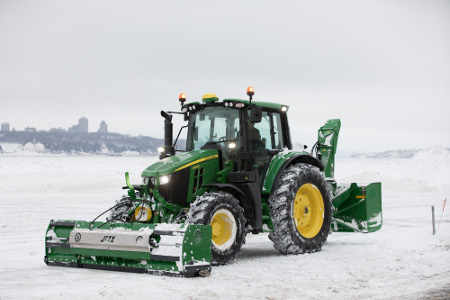 6120M with optional front hitch
6120M with optional front hitch
For all 6M Series Tractors, an optional integrated John Deere Category 3N front hitch with hook-end draft links can be factory installed. The high lift capacity of 4400 kg (9,700 lb) maximum and 3300 kg (7,275 lb) through the full lift range ensures compatibility with heavy front implements and ballasts. If the tractor is not equipped with Triple-Link Suspension (TLS™), an accumulator will be installed to ensure driving comfort. The economy front hitch allows:
- Maximum uptime with quick and easy changing from folded to working position
- The operator to be highly flexible with the front ballast
- Optional availability of integrated front power take-off (PTO)
Increase visibility and productivity with light packages
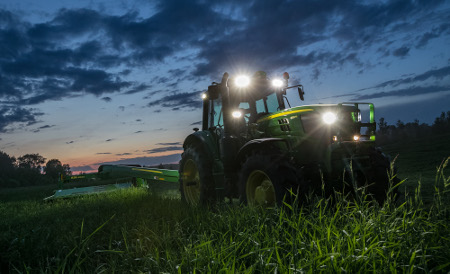 6155M with Premium light-emitting diode (LED) light package
6155M with Premium light-emitting diode (LED) light package
Lights on the 6M Series Tractors have been positioned and designed to provide maximum visibility to the front, sides, and rear to increase productivity in any operating conditions. The updated cab lighting pattern provides 330 degrees of coverage while the hood lighting provides the remaining 30 degrees. You have two options to upgrade lighting with the Economy and Premium light packages available:
- Economy light package
- Two additional work lights in the front, side, and rear
- Premium light package
- Two additional work lights in the front, side, and rear
- All lights are LED lights
Both packages require the 14-V/150-amp alternator (code 8741) and 12-V/174-amp-hr battery (code 8747).
Stay connected to all machines from anywhere with JDLink™ system
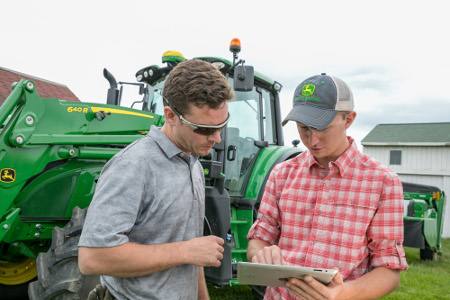 John Deere 6155M with StarFire™ 6000 Receiver and tablet with JDLink
John Deere 6155M with StarFire™ 6000 Receiver and tablet with JDLink
JDLink is available from the factory for all 6M Tractors. JDLink is John Deere's telematics system connecting all machines in the field with the office and mobile devices. The technology is based on a Modular Telematics Gateway (MTG) controller that collects and transmits data via cellular network using selective data points in near real-time. Information and features can be accessed through Operations Center, the JDLink tab on MyJohnDeere.com, or by using the JDLink app. JDLink also enables you to:
- Access important machine information like machine hours
- Keep track of your fleets
- Monitor work progress
- Manage logistics
- Analyze and optimize machine performance
- Receive alter SMS or email messages
- Perform remote operator support
- Automate data exchange
You can choose between two subscription levels: JDLink Access and JDLink Connect.
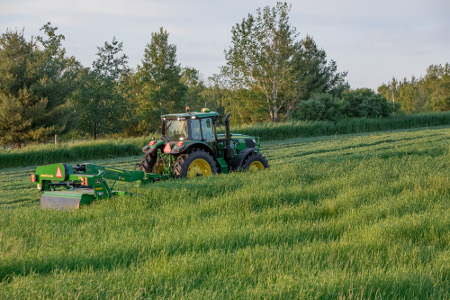 John Deere 6155M and 835 Mower Conditioner with StarFire 6000 Receiver and JDLink
John Deere 6155M and 835 Mower Conditioner with StarFire 6000 Receiver and JDLink
Improved access for serviceability with side panels and oil dipstick location
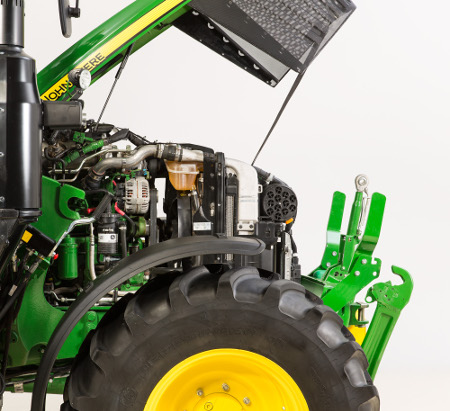 Removable side panels for easy access on 6120M
Removable side panels for easy access on 6120M
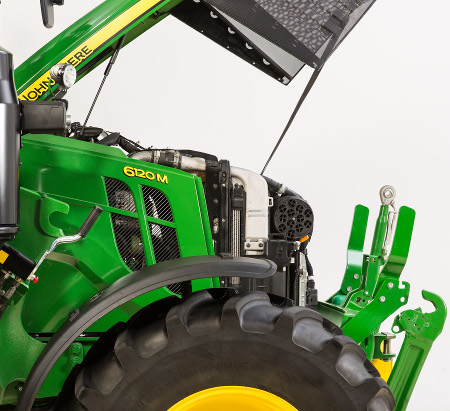 Side panels attached to the 6120M
Side panels attached to the 6120M
6M Series Tractors have been redesigned to meet stringent reliability and serviceability requirements. Daily service requirements have been reduced and are simple to accomplish with improved accessibility to the engine. All 6M models are equipped with a 60-degree hood, and the 6110M and 6120M feature removeable side panels, allowing easy access to reduce time and make serviceability even easier. These features allow you to quickly and easily check parts like:
- Engine oil filter
- Engine fuel filter
- Coolant recovery tank
- Radiator cleanout screens
- Air cleaner
Additionally, the oil dipstick on the 6110M and 6120M allows you to check the engine oil level without opening the hood.
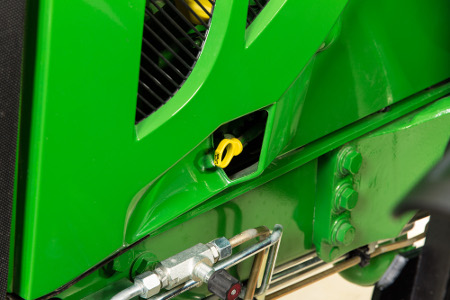 Updated oil dipstick location on 6110M-6120M
Updated oil dipstick location on 6110M-6120M
Complete tasks quickly and easily with the 4240/4640 Universal Display
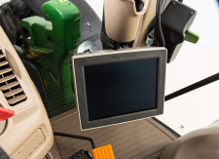 John Deere 4240 Universal Display
John Deere 4240 Universal Display
The latest John Deere display technology offered in a moveable and user-friendly experience is available with the John Deere 4240 and 4640 Universal Displays. These displays enable AutoTrac™ guidance that provides enhanced usability, increased performance, and greater operator choice. Additional benefits include:
- Support flags – document a point, line, or area of a field that needs later attention
- Enhanced data merging functionalities for setup data (no more overwrites)
- AutoTrac guidance improvements – boundary track and preview for guidance lines, tramlines, and machine access
- Keeping the implement on the perfect track even in hilly conditions with AutoTrac Implement Guidance (passive)
Features
Tailored to fit: John Deere specialty solutions
The 5G Final Tier 4 (FT4) Specialty Series now brings a narrow, ultra-narrow, and low-profile option to specialty applications.
The 5GV Series is built to operate in vineyards with a minimum working width of 108.8 cm (42.8 in.) from rear tire to rear tire. The 5GV Series cab, with an overall width of 108.1 cm (42.6 in.), is designed to pass between narrow vineyard rows. The 5GN features an extra- wide cab of 127.5 cm (50.2 in.). The 5GL series is manufactured with orchardists in mind. This low-profile tractor has an approximate height of 135.89cm (53.5 in.) and width of 152.4cm (60 in.) (depending on tire configuration), which makes it ideal for operating in orchards that are laden with heavy fruit.
The two-door cab on the 5GN and 5GV models offers the operator yet another convenience of entering and exiting from either side. With a distance of 560 mm (22.1 in.) between the right- and left-hand side consoles and a play of 285 mm (11.2 in.) between seat and steering wheel, the 5G Series provides one of the roomiest cabs in the specialty tractor market.
Overview of minimum working widths
 Overview of minimum working widths
Overview of minimum working widths
5G Specialty Series basic feature overview:
| Feature overview | 5GN | 5GV | 5GL |
| 100 hp (74 kW), 4-cylinder / 3.4 L (0.9 gal.) | 5100GN | N/A | N/A |
| 90 hp (63 kW), 4-cylinder / 3.4 L (0.9 gal.) | 5090GN | 5090GV | N/A |
| 75 hp (55 kW), 4-cylinder / 3.4 L (0.9 gal.) | 5075GN | 5075GV | 5075GL |
| Two-wheel drive (2WD) / four-wheel drive (4WD) | Only 4WD | Only 4WD | Only 4WD |
| Cab / open operator station (OOS) | Available | Available | Only OOS |
 5GV cab on 5GN Tractor
5GV cab on 5GN Tractor
The 5G Series has also expanded its platform offerings to include a 5GV cab on a 5GN Tractor. This option combines the fit of 5GV with the wider stance of a 5GN, providing excellent stability paired with the narrowest cab offering available in the 5G portfolio.

John Deere value
Performance: tailored to fit – matching narrow widths and low heights to producers’ high value crop applications.
Auxiliary fuel tank (5GN)
The 5GN models have an optional auxiliary fuel tank available, which increases the fuel tank capacity by up to 38 percent on the 5075GN and up to 33 percent on the 5090GN and 5100GN.
The increased capacity allows for more productive time in the field with fewer stops for refueling.
| Machine | Code | Fuel tank capacity | Code | Auxiliary tank capacity |
| 5075GN | Base | 86 L (22.7 gal.) | 8313 | 28.4 L (7.5 gal.) |
| 5090GN | Base | 73 L (19.3 gal.) | 8313 | 28.4 L (7.5 gal.) |
| 5100GN | Base | 73 L (19.3 gal.) | 8313 | 28.4 L (7.5 gal.) |
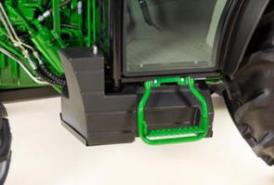 Auxiliary fuel tank
Auxiliary fuel tank
Powerful Final Tier 4 (FT4) engines
The 5G Specialty Series Tractors are equipped with powerful FT4 diesel engines.
All GN, GV, and GL models are equipped with a robust FPT Industrial 4-cylinder, 3.4-L (207.5-cu in.) displacement engine that offers real versatility and performance for all kinds of specialty operations.
| Engine overview | 5GN | 5GV | 5GL |
| 74.6 kW (100 hp), 4-cylinder / 3.4 L (207.5 cu in.) | 5100GN | Not available | Not available |
| 67.1 kW (90 hp), 4-cylinder / 3.4 L (207.5 cu in.) | 5090GN | 5090GV | Not available |
| 55.9 kW (75 hp), 4-cylinder / 3.4 L (207.5 cu in.) | 5075GN | 5075GV | 5075GL |
Supporting the narrow dimensions of the 5GV Series
The narrow width of the 5GV Series requires a compact engine solution. The compact 3.4-L (207.5-cu in.) engine supports the envelope of the 5GV Series entering super narrow vineyards as well as the turning radius at the end of a row.
Performance - made to measure
The engine ensures high productivity under tough working conditions. With a torque of 401 Nm (295.7 lb-ft) for the 74.6-kW (100-hp) model, the engine ensures the optimal performance for versatile operations.
John Deere value:
Performance: the powerful FT4 engines support the narrow machine envelope of the 5G Specialty Series and offer a high torque at rated rpm, which provides a high performance.
Heavy-duty weight
The 5G Series Tractors are heavy-duty utility tractors in two narrow chassis widths. Heavier gross vehicle weight means more down force to keep implements in the ground. Heavier equipment also leads to improved traction and performance in the field. The 5G Series Tractors have the weight to power through tough jobs.
| Machine | Four-wheel drive (4WD) rollover protective structure (ROPS) | 4WD cab |
| 5075GV | 2530 kg (5577 lb) | 2745 kg (6051 lb) |
| 5090GV | 2530 kg (5577 lb) | 2745 kg (6051 lb) |
| 5075GN | 2660 kg (5864 lb) | 2975 kg (6558 lb) |
| 5090GN | 2660 kg (5864 lb) | 2975 kg (6558 lb) |
| 5100GN | 2660 kg (5864 lb) | 2975 kg (6558 lb) |
| 5075GL | 2670 kg (5886 lb) | No cab option |
Excellent serviceability reduces operational costs and improves productivity
Regular service and maintenance are essential to the performance, productivity, and longevity of the tractor.
- Easy access to regular service points minimizes service time.
- Tractors are equipped with onboard self-diagnostic capabilities and are fully compatible with the John Deere-exclusive Service ADVISOR™ system.
- Daily service requirements are minimal and simple to accomplish. Most service interval requirements can be performed with a basic understanding of procedures and common tools.
All items in the daily service schedule can be performed without the use of tools:
- Convenient access to engine oil, hydraulic oil, coolant level, and water separator
- Easy access to periodic engine maintenance checks by simply raising the hood
- Single-point latch mechanism and self-contained leash ensure easy hood opening and closure
NOTE: Always refer to the operator’s manual for complete maintenance and service recommendations.
Outstanding hydraulic performance
The John Deere 5G Series provides an outstanding total hydraulic system flow of 126.4 L/min (33.4 gpm) with an optional third hydraulic pump.
This hydraulic system ensures excellent hydraulic performance and capacity:
- Precise steering without diverting oil flow from the selective control valves (SCVs) and rockshaft is ideal when maneuvering and operating an implement at the same time as turning at the headland
- Ensures easy power steering with heavy loads on the front of the tractor
- Supplies plenty of power to run hydraulic motors
- Fast cycle times even during the simultaneous usage of various hydraulic driven implements
Hydraulic performance |
5075GV | 5090GV | 5075GN | 5090GN | 5100GN | 5075GL |
| Steering and transmission | 29.9 L/min (7.9 gpm) | |||||
| Second pump - SCV and hitch | 66.6 L/min (17.6 gpm) | |||||
| Third pump - rockshaft | 29.9 L/min (7.9 gpm) | |||||
| Total hydraulic flow | 126.4 L/min (33.4 gpm) | |||||
Versatile rear hitch
The heavy-duty 3-point hitch design on the 5G Series provides a standard maximum lift of 2590 kg (5,710 lb) at the ball ends. An optional additional lift cylinder is available for the 5GN Series, which increases the maximum lift capacity by 510 kg (1,124 lb) to 3100 kg (6,834 lb) at the ball ends.
Hooking up implements is quick and simple with the standard Category 2 3-point hitch on the 5GN. Hooking up implements that require Category 1 or Category 1N is also possible and requires very little time with the 5GV and 5GL.
 Optional extra lift capacity shown on the 5GN photo
Optional extra lift capacity shown on the 5GN photo
| Code | Description | Information | Availability |
| 8490 | Additional lift cylinder | Includes additional lift cylinder (maximum lift capacity at ball ends: 3100 kg [6,834 lb]) | 5GN |
| 4130 | Fixed ball ends | 3-point hitch with fixed ball ends for draft links | 5GN, 5GV |
| 4131 | Adjustable ball ends | 3-point hitch with adjustable ball ends for draft links | 5GN, 5GV |
| 4132 | Adjustable quick couplers | 3-point hitch with adjustable quick couplers for draft links | 5GN, 5GV, 5GL |
| 4151 | Hydraulic lift rod | Hydraulically adjust lift arm to tilt or level implement | 5GN, 5GV, 5GL |
| 4152 | Mechanical lift rod | Mechanically adjust lift arm to tilt or level implement | 5GN, 5GV, 5GL |
 Lift rods
Lift rods
John Deere value
Performance: higher lift capacity for a wider variety of implements and strong performance means real versatility.
Transmission
The 5G Series comes standard with a 24 forward/12 reverse (24F/12R) PowrReverser™ transmission. The 24F/12R transmission provides 24 forward speeds and 12 reverse speeds for transport speeds of up to 40 km/h (24.9 mph). The transmission provides convenient Hi-Lo and declutch push-button controls. The Hi-Lo feature benefits operators who frequently transport their tractors from field to field or find themselves in bog-down situations during rear power take-off (PTO) work.
Users can push the rabbit button (high) without having to depress the clutch to get an increase in speed. They can also push the turtle button (low) to get a decrease in speed, similar to downshifting or engine braking without having to grab another gear. The PowrReverser transmission has a built-in engagement override valve for additional safety. This valve requires the clutch pedal to be depressed one time after each engine start before the transmission will begin to operate normally, giving the operator another opportunity to put all focus on the tractor. A neutral start switch requires the PowrReverser lever to be in the neutral position to start the engine.
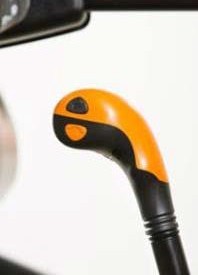 Gear-shift lever with Hi-Lo selectors
Gear-shift lever with Hi-Lo selectors
| 24F/12R PowrReverser | |
| Speed (km/h) | 0.5 to 40 km/h (0.3 to 24.9 mph) |
| Creeper range | Yes |
| Configuration | Four-wheel drive (4WD) |
| Clutch type | Multi-disc wet clutch |
| Clutching required to shift | No |
| Reverser | PowrReverser |
| Hi-Lo | Electrohydraulic |
| Mechanical front-wheel drive (MFWD) engagement | Electrohydraulic, if MFWD option installed |
| PTO engagement | Electrohydraulic |
| Differential lock engagement | Electrohydraulic |
Features
Tailored to fit: John Deere specialty solutions
The 5G Final Tier 4 (FT4) Specialty Series now brings a narrow, ultra-narrow, and low-profile option to specialty applications.
The 5GV Series is built to operate in vineyards with a minimum working width of 108.8 cm (42.8 in.) from rear tire to rear tire. The 5GV Series cab, with an overall width of 108.1 cm (42.6 in.), is designed to pass between narrow vineyard rows. The 5GN features an extra- wide cab of 127.5 cm (50.2 in.). The 5GL series is manufactured with orchardists in mind. This low-profile tractor has an approximate height of 135.89cm (53.5 in.) and width of 152.4cm (60 in.) (depending on tire configuration), which makes it ideal for operating in orchards that are laden with heavy fruit.
The two-door cab on the 5GN and 5GV models offers the operator yet another convenience of entering and exiting from either side. With a distance of 560 mm (22.1 in.) between the right- and left-hand side consoles and a play of 285 mm (11.2 in.) between seat and steering wheel, the 5G Series provides one of the roomiest cabs in the specialty tractor market.
Overview of minimum working widths
 Overview of minimum working widths
Overview of minimum working widths
5G Specialty Series basic feature overview:
| Feature overview | 5GN | 5GV | 5GL |
| 100 hp (74 kW), 4-cylinder / 3.4 L (0.9 gal.) | 5100GN | N/A | N/A |
| 90 hp (63 kW), 4-cylinder / 3.4 L (0.9 gal.) | 5090GN | 5090GV | N/A |
| 75 hp (55 kW), 4-cylinder / 3.4 L (0.9 gal.) | 5075GN | 5075GV | 5075GL |
| Two-wheel drive (2WD) / four-wheel drive (4WD) | Only 4WD | Only 4WD | Only 4WD |
| Cab / open operator station (OOS) | Available | Available | Only OOS |
 5GV cab on 5GN Tractor
5GV cab on 5GN Tractor
The 5G Series has also expanded its platform offerings to include a 5GV cab on a 5GN Tractor. This option combines the fit of 5GV with the wider stance of a 5GN, providing excellent stability paired with the narrowest cab offering available in the 5G portfolio.

John Deere value
Performance: tailored to fit – matching narrow widths and low heights to producers’ high value crop applications.
Auxiliary fuel tank (5GN)
The 5GN models have an optional auxiliary fuel tank available, which increases the fuel tank capacity by up to 38 percent on the 5075GN and up to 33 percent on the 5090GN and 5100GN.
The increased capacity allows for more productive time in the field with fewer stops for refueling.
| Machine | Code | Fuel tank capacity | Code | Auxiliary tank capacity |
| 5075GN | Base | 86 L (22.7 gal.) | 8313 | 28.4 L (7.5 gal.) |
| 5090GN | Base | 73 L (19.3 gal.) | 8313 | 28.4 L (7.5 gal.) |
| 5100GN | Base | 73 L (19.3 gal.) | 8313 | 28.4 L (7.5 gal.) |
 Auxiliary fuel tank
Auxiliary fuel tank
Powerful Final Tier 4 (FT4) engines
The 5G Specialty Series Tractors are equipped with powerful FT4 diesel engines.
All GN, GV, and GL models are equipped with a robust FPT Industrial 4-cylinder, 3.4-L (207.5-cu in.) displacement engine that offers real versatility and performance for all kinds of specialty operations.
| Engine overview | 5GN | 5GV | 5GL |
| 74.6 kW (100 hp), 4-cylinder / 3.4 L (207.5 cu in.) | 5100GN | Not available | Not available |
| 67.1 kW (90 hp), 4-cylinder / 3.4 L (207.5 cu in.) | 5090GN | 5090GV | Not available |
| 55.9 kW (75 hp), 4-cylinder / 3.4 L (207.5 cu in.) | 5075GN | 5075GV | 5075GL |
Supporting the narrow dimensions of the 5GV Series
The narrow width of the 5GV Series requires a compact engine solution. The compact 3.4-L (207.5-cu in.) engine supports the envelope of the 5GV Series entering super narrow vineyards as well as the turning radius at the end of a row.
Performance - made to measure
The engine ensures high productivity under tough working conditions. With a torque of 401 Nm (295.7 lb-ft) for the 74.6-kW (100-hp) model, the engine ensures the optimal performance for versatile operations.
John Deere value:
Performance: the powerful FT4 engines support the narrow machine envelope of the 5G Specialty Series and offer a high torque at rated rpm, which provides a high performance.
Heavy-duty weight
The 5G Series Tractors are heavy-duty utility tractors in two narrow chassis widths. Heavier gross vehicle weight means more down force to keep implements in the ground. Heavier equipment also leads to improved traction and performance in the field. The 5G Series Tractors have the weight to power through tough jobs.
| Machine | Four-wheel drive (4WD) rollover protective structure (ROPS) | 4WD cab |
| 5075GV | 2530 kg (5577 lb) | 2745 kg (6051 lb) |
| 5090GV | 2530 kg (5577 lb) | 2745 kg (6051 lb) |
| 5075GN | 2660 kg (5864 lb) | 2975 kg (6558 lb) |
| 5090GN | 2660 kg (5864 lb) | 2975 kg (6558 lb) |
| 5100GN | 2660 kg (5864 lb) | 2975 kg (6558 lb) |
| 5075GL | 2670 kg (5886 lb) | No cab option |
Excellent serviceability reduces operational costs and improves productivity
Regular service and maintenance are essential to the performance, productivity, and longevity of the tractor.
- Easy access to regular service points minimizes service time.
- Tractors are equipped with onboard self-diagnostic capabilities and are fully compatible with the John Deere-exclusive Service ADVISOR™ system.
- Daily service requirements are minimal and simple to accomplish. Most service interval requirements can be performed with a basic understanding of procedures and common tools.
All items in the daily service schedule can be performed without the use of tools:
- Convenient access to engine oil, hydraulic oil, coolant level, and water separator
- Easy access to periodic engine maintenance checks by simply raising the hood
- Single-point latch mechanism and self-contained leash ensure easy hood opening and closure
NOTE: Always refer to the operator’s manual for complete maintenance and service recommendations.
Outstanding hydraulic performance
The John Deere 5G Series provides an outstanding total hydraulic system flow of 126.4 L/min (33.4 gpm) with an optional third hydraulic pump.
This hydraulic system ensures excellent hydraulic performance and capacity:
- Precise steering without diverting oil flow from the selective control valves (SCVs) and rockshaft is ideal when maneuvering and operating an implement at the same time as turning at the headland
- Ensures easy power steering with heavy loads on the front of the tractor
- Supplies plenty of power to run hydraulic motors
- Fast cycle times even during the simultaneous usage of various hydraulic driven implements
Hydraulic performance |
5075GV | 5090GV | 5075GN | 5090GN | 5100GN | 5075GL |
| Steering and transmission | 29.9 L/min (7.9 gpm) | |||||
| Second pump - SCV and hitch | 66.6 L/min (17.6 gpm) | |||||
| Third pump - rockshaft | 29.9 L/min (7.9 gpm) | |||||
| Total hydraulic flow | 126.4 L/min (33.4 gpm) | |||||
Versatile rear hitch
The heavy-duty 3-point hitch design on the 5G Series provides a standard maximum lift of 2590 kg (5,710 lb) at the ball ends. An optional additional lift cylinder is available for the 5GN Series, which increases the maximum lift capacity by 510 kg (1,124 lb) to 3100 kg (6,834 lb) at the ball ends.
Hooking up implements is quick and simple with the standard Category 2 3-point hitch on the 5GN. Hooking up implements that require Category 1 or Category 1N is also possible and requires very little time with the 5GV and 5GL.
 Optional extra lift capacity shown on the 5GN photo
Optional extra lift capacity shown on the 5GN photo
| Code | Description | Information | Availability |
| 8490 | Additional lift cylinder | Includes additional lift cylinder (maximum lift capacity at ball ends: 3100 kg [6,834 lb]) | 5GN |
| 4130 | Fixed ball ends | 3-point hitch with fixed ball ends for draft links | 5GN, 5GV |
| 4131 | Adjustable ball ends | 3-point hitch with adjustable ball ends for draft links | 5GN, 5GV |
| 4132 | Adjustable quick couplers | 3-point hitch with adjustable quick couplers for draft links | 5GN, 5GV, 5GL |
| 4151 | Hydraulic lift rod | Hydraulically adjust lift arm to tilt or level implement | 5GN, 5GV, 5GL |
| 4152 | Mechanical lift rod | Mechanically adjust lift arm to tilt or level implement | 5GN, 5GV, 5GL |
 Lift rods
Lift rods
John Deere value
Performance: higher lift capacity for a wider variety of implements and strong performance means real versatility.
Transmission
The 5G Series comes standard with a 24 forward/12 reverse (24F/12R) PowrReverser™ transmission. The 24F/12R transmission provides 24 forward speeds and 12 reverse speeds for transport speeds of up to 40 km/h (24.9 mph). The transmission provides convenient Hi-Lo and declutch push-button controls. The Hi-Lo feature benefits operators who frequently transport their tractors from field to field or find themselves in bog-down situations during rear power take-off (PTO) work.
Users can push the rabbit button (high) without having to depress the clutch to get an increase in speed. They can also push the turtle button (low) to get a decrease in speed, similar to downshifting or engine braking without having to grab another gear. The PowrReverser transmission has a built-in engagement override valve for additional safety. This valve requires the clutch pedal to be depressed one time after each engine start before the transmission will begin to operate normally, giving the operator another opportunity to put all focus on the tractor. A neutral start switch requires the PowrReverser lever to be in the neutral position to start the engine.
 Gear-shift lever with Hi-Lo selectors
Gear-shift lever with Hi-Lo selectors
| 24F/12R PowrReverser | |
| Speed (km/h) | 0.5 to 40 km/h (0.3 to 24.9 mph) |
| Creeper range | Yes |
| Configuration | Four-wheel drive (4WD) |
| Clutch type | Multi-disc wet clutch |
| Clutching required to shift | No |
| Reverser | PowrReverser |
| Hi-Lo | Electrohydraulic |
| Mechanical front-wheel drive (MFWD) engagement | Electrohydraulic, if MFWD option installed |
| PTO engagement | Electrohydraulic |
| Differential lock engagement | Electrohydraulic |
Features
Tailored to fit: John Deere specialty solutions
The 5G Final Tier 4 (FT4) Specialty Series now brings a narrow, ultra-narrow, and low-profile option to specialty applications.
The 5GV Series is built to operate in vineyards with a minimum working width of 108.8 cm (42.8 in.) from rear tire to rear tire. The 5GV Series cab, with an overall width of 108.1 cm (42.6 in.), is designed to pass between narrow vineyard rows. The 5GN features an extra- wide cab of 127.5 cm (50.2 in.). The 5GL series is manufactured with orchardists in mind. This low-profile tractor has an approximate height of 135.89cm (53.5 in.) and width of 152.4cm (60 in.) (depending on tire configuration), which makes it ideal for operating in orchards that are laden with heavy fruit.
The two-door cab on the 5GN and 5GV models offers the operator yet another convenience of entering and exiting from either side. With a distance of 560 mm (22.1 in.) between the right- and left-hand side consoles and a play of 285 mm (11.2 in.) between seat and steering wheel, the 5G Series provides one of the roomiest cabs in the specialty tractor market.
Overview of minimum working widths
 Overview of minimum working widths
Overview of minimum working widths
5G Specialty Series basic feature overview:
| Feature overview | 5GN | 5GV | 5GL |
| 100 hp (74 kW), 4-cylinder / 3.4 L (0.9 gal.) | 5100GN | N/A | N/A |
| 90 hp (63 kW), 4-cylinder / 3.4 L (0.9 gal.) | 5090GN | 5090GV | N/A |
| 75 hp (55 kW), 4-cylinder / 3.4 L (0.9 gal.) | 5075GN | 5075GV | 5075GL |
| Two-wheel drive (2WD) / four-wheel drive (4WD) | Only 4WD | Only 4WD | Only 4WD |
| Cab / open operator station (OOS) | Available | Available | Only OOS |
 5GV cab on 5GN Tractor
5GV cab on 5GN Tractor
The 5G Series has also expanded its platform offerings to include a 5GV cab on a 5GN Tractor. This option combines the fit of 5GV with the wider stance of a 5GN, providing excellent stability paired with the narrowest cab offering available in the 5G portfolio.

John Deere value
Performance: tailored to fit – matching narrow widths and low heights to producers’ high value crop applications.
Auxiliary fuel tank (5GN)
The 5GN models have an optional auxiliary fuel tank available, which increases the fuel tank capacity by up to 38 percent on the 5075GN and up to 33 percent on the 5090GN and 5100GN.
The increased capacity allows for more productive time in the field with fewer stops for refueling.
| Machine | Code | Fuel tank capacity | Code | Auxiliary tank capacity |
| 5075GN | Base | 86 L (22.7 gal.) | 8313 | 28.4 L (7.5 gal.) |
| 5090GN | Base | 73 L (19.3 gal.) | 8313 | 28.4 L (7.5 gal.) |
| 5100GN | Base | 73 L (19.3 gal.) | 8313 | 28.4 L (7.5 gal.) |
 Auxiliary fuel tank
Auxiliary fuel tank
Powerful Final Tier 4 (FT4) engines
The 5G Specialty Series Tractors are equipped with powerful FT4 diesel engines.
All GN, GV, and GL models are equipped with a robust FPT Industrial 4-cylinder, 3.4-L (207.5-cu in.) displacement engine that offers real versatility and performance for all kinds of specialty operations.
| Engine overview | 5GN | 5GV | 5GL |
| 74.6 kW (100 hp), 4-cylinder / 3.4 L (207.5 cu in.) | 5100GN | Not available | Not available |
| 67.1 kW (90 hp), 4-cylinder / 3.4 L (207.5 cu in.) | 5090GN | 5090GV | Not available |
| 55.9 kW (75 hp), 4-cylinder / 3.4 L (207.5 cu in.) | 5075GN | 5075GV | 5075GL |
Supporting the narrow dimensions of the 5GV Series
The narrow width of the 5GV Series requires a compact engine solution. The compact 3.4-L (207.5-cu in.) engine supports the envelope of the 5GV Series entering super narrow vineyards as well as the turning radius at the end of a row.
Performance - made to measure
The engine ensures high productivity under tough working conditions. With a torque of 401 Nm (295.7 lb-ft) for the 74.6-kW (100-hp) model, the engine ensures the optimal performance for versatile operations.
John Deere value:
Performance: the powerful FT4 engines support the narrow machine envelope of the 5G Specialty Series and offer a high torque at rated rpm, which provides a high performance.
Heavy-duty weight
The 5G Series Tractors are heavy-duty utility tractors in two narrow chassis widths. Heavier gross vehicle weight means more down force to keep implements in the ground. Heavier equipment also leads to improved traction and performance in the field. The 5G Series Tractors have the weight to power through tough jobs.
| Machine | Four-wheel drive (4WD) rollover protective structure (ROPS) | 4WD cab |
| 5075GV | 2530 kg (5577 lb) | 2745 kg (6051 lb) |
| 5090GV | 2530 kg (5577 lb) | 2745 kg (6051 lb) |
| 5075GN | 2660 kg (5864 lb) | 2975 kg (6558 lb) |
| 5090GN | 2660 kg (5864 lb) | 2975 kg (6558 lb) |
| 5100GN | 2660 kg (5864 lb) | 2975 kg (6558 lb) |
| 5075GL | 2670 kg (5886 lb) | No cab option |
Excellent serviceability reduces operational costs and improves productivity
Regular service and maintenance are essential to the performance, productivity, and longevity of the tractor.
- Easy access to regular service points minimizes service time.
- Tractors are equipped with onboard self-diagnostic capabilities and are fully compatible with the John Deere-exclusive Service ADVISOR™ system.
- Daily service requirements are minimal and simple to accomplish. Most service interval requirements can be performed with a basic understanding of procedures and common tools.
All items in the daily service schedule can be performed without the use of tools:
- Convenient access to engine oil, hydraulic oil, coolant level, and water separator
- Easy access to periodic engine maintenance checks by simply raising the hood
- Single-point latch mechanism and self-contained leash ensure easy hood opening and closure
NOTE: Always refer to the operator’s manual for complete maintenance and service recommendations.
Outstanding hydraulic performance
The John Deere 5G Series provides an outstanding total hydraulic system flow of 126.4 L/min (33.4 gpm) with an optional third hydraulic pump.
This hydraulic system ensures excellent hydraulic performance and capacity:
- Precise steering without diverting oil flow from the selective control valves (SCVs) and rockshaft is ideal when maneuvering and operating an implement at the same time as turning at the headland
- Ensures easy power steering with heavy loads on the front of the tractor
- Supplies plenty of power to run hydraulic motors
- Fast cycle times even during the simultaneous usage of various hydraulic driven implements
Hydraulic performance |
5075GV | 5090GV | 5075GN | 5090GN | 5100GN | 5075GL |
| Steering and transmission | 29.9 L/min (7.9 gpm) | |||||
| Second pump - SCV and hitch | 66.6 L/min (17.6 gpm) | |||||
| Third pump - rockshaft | 29.9 L/min (7.9 gpm) | |||||
| Total hydraulic flow | 126.4 L/min (33.4 gpm) | |||||
Versatile rear hitch
The heavy-duty 3-point hitch design on the 5G Series provides a standard maximum lift of 2590 kg (5,710 lb) at the ball ends. An optional additional lift cylinder is available for the 5GN Series, which increases the maximum lift capacity by 510 kg (1,124 lb) to 3100 kg (6,834 lb) at the ball ends.
Hooking up implements is quick and simple with the standard Category 2 3-point hitch on the 5GN. Hooking up implements that require Category 1 or Category 1N is also possible and requires very little time with the 5GV and 5GL.
 Optional extra lift capacity shown on the 5GN photo
Optional extra lift capacity shown on the 5GN photo
| Code | Description | Information | Availability |
| 8490 | Additional lift cylinder | Includes additional lift cylinder (maximum lift capacity at ball ends: 3100 kg [6,834 lb]) | 5GN |
| 4130 | Fixed ball ends | 3-point hitch with fixed ball ends for draft links | 5GN, 5GV |
| 4131 | Adjustable ball ends | 3-point hitch with adjustable ball ends for draft links | 5GN, 5GV |
| 4132 | Adjustable quick couplers | 3-point hitch with adjustable quick couplers for draft links | 5GN, 5GV, 5GL |
| 4151 | Hydraulic lift rod | Hydraulically adjust lift arm to tilt or level implement | 5GN, 5GV, 5GL |
| 4152 | Mechanical lift rod | Mechanically adjust lift arm to tilt or level implement | 5GN, 5GV, 5GL |
 Lift rods
Lift rods
John Deere value
Performance: higher lift capacity for a wider variety of implements and strong performance means real versatility.
Transmission
The 5G Series comes standard with a 24 forward/12 reverse (24F/12R) PowrReverser™ transmission. The 24F/12R transmission provides 24 forward speeds and 12 reverse speeds for transport speeds of up to 40 km/h (24.9 mph). The transmission provides convenient Hi-Lo and declutch push-button controls. The Hi-Lo feature benefits operators who frequently transport their tractors from field to field or find themselves in bog-down situations during rear power take-off (PTO) work.
Users can push the rabbit button (high) without having to depress the clutch to get an increase in speed. They can also push the turtle button (low) to get a decrease in speed, similar to downshifting or engine braking without having to grab another gear. The PowrReverser transmission has a built-in engagement override valve for additional safety. This valve requires the clutch pedal to be depressed one time after each engine start before the transmission will begin to operate normally, giving the operator another opportunity to put all focus on the tractor. A neutral start switch requires the PowrReverser lever to be in the neutral position to start the engine.
 Gear-shift lever with Hi-Lo selectors
Gear-shift lever with Hi-Lo selectors
| 24F/12R PowrReverser | |
| Speed (km/h) | 0.5 to 40 km/h (0.3 to 24.9 mph) |
| Creeper range | Yes |
| Configuration | Four-wheel drive (4WD) |
| Clutch type | Multi-disc wet clutch |
| Clutching required to shift | No |
| Reverser | PowrReverser |
| Hi-Lo | Electrohydraulic |
| Mechanical front-wheel drive (MFWD) engagement | Electrohydraulic, if MFWD option installed |
| PTO engagement | Electrohydraulic |
| Differential lock engagement | Electrohydraulic |
Features
Tailored to fit: John Deere specialty solutions
The 5G Final Tier 4 (FT4) Specialty Series now brings a narrow, ultra-narrow, and low-profile option to specialty applications.
The 5GV Series is built to operate in vineyards with a minimum working width of 108.8 cm (42.8 in.) from rear tire to rear tire. The 5GV Series cab, with an overall width of 108.1 cm (42.6 in.), is designed to pass between narrow vineyard rows. The 5GN features an extra- wide cab of 127.5 cm (50.2 in.). The 5GL series is manufactured with orchardists in mind. This low-profile tractor has an approximate height of 135.89cm (53.5 in.) and width of 152.4cm (60 in.) (depending on tire configuration), which makes it ideal for operating in orchards that are laden with heavy fruit.
The two-door cab on the 5GN and 5GV models offers the operator yet another convenience of entering and exiting from either side. With a distance of 560 mm (22.1 in.) between the right- and left-hand side consoles and a play of 285 mm (11.2 in.) between seat and steering wheel, the 5G Series provides one of the roomiest cabs in the specialty tractor market.
Overview of minimum working widths
 Overview of minimum working widths
Overview of minimum working widths
5G Specialty Series basic feature overview:
| Feature overview | 5GN | 5GV | 5GL |
| 100 hp (74 kW), 4-cylinder / 3.4 L (0.9 gal.) | 5100GN | N/A | N/A |
| 90 hp (63 kW), 4-cylinder / 3.4 L (0.9 gal.) | 5090GN | 5090GV | N/A |
| 75 hp (55 kW), 4-cylinder / 3.4 L (0.9 gal.) | 5075GN | 5075GV | 5075GL |
| Two-wheel drive (2WD) / four-wheel drive (4WD) | Only 4WD | Only 4WD | Only 4WD |
| Cab / open operator station (OOS) | Available | Available | Only OOS |
 5GV cab on 5GN Tractor
5GV cab on 5GN Tractor
The 5G Series has also expanded its platform offerings to include a 5GV cab on a 5GN Tractor. This option combines the fit of 5GV with the wider stance of a 5GN, providing excellent stability paired with the narrowest cab offering available in the 5G portfolio.

John Deere value
Performance: tailored to fit – matching narrow widths and low heights to producers’ high value crop applications.
Auxiliary fuel tank (5GN)
The 5GN models have an optional auxiliary fuel tank available, which increases the fuel tank capacity by up to 38 percent on the 5075GN and up to 33 percent on the 5090GN and 5100GN.
The increased capacity allows for more productive time in the field with fewer stops for refueling.
| Machine | Code | Fuel tank capacity | Code | Auxiliary tank capacity |
| 5075GN | Base | 86 L (22.7 gal.) | 8313 | 28.4 L (7.5 gal.) |
| 5090GN | Base | 73 L (19.3 gal.) | 8313 | 28.4 L (7.5 gal.) |
| 5100GN | Base | 73 L (19.3 gal.) | 8313 | 28.4 L (7.5 gal.) |
 Auxiliary fuel tank
Auxiliary fuel tank
Powerful Final Tier 4 (FT4) engines
The 5G Specialty Series Tractors are equipped with powerful FT4 diesel engines.
All GN, GV, and GL models are equipped with a robust FPT Industrial 4-cylinder, 3.4-L (207.5-cu in.) displacement engine that offers real versatility and performance for all kinds of specialty operations.
| Engine overview | 5GN | 5GV | 5GL |
| 74.6 kW (100 hp), 4-cylinder / 3.4 L (207.5 cu in.) | 5100GN | Not available | Not available |
| 67.1 kW (90 hp), 4-cylinder / 3.4 L (207.5 cu in.) | 5090GN | 5090GV | Not available |
| 55.9 kW (75 hp), 4-cylinder / 3.4 L (207.5 cu in.) | 5075GN | 5075GV | 5075GL |
Supporting the narrow dimensions of the 5GV Series
The narrow width of the 5GV Series requires a compact engine solution. The compact 3.4-L (207.5-cu in.) engine supports the envelope of the 5GV Series entering super narrow vineyards as well as the turning radius at the end of a row.
Performance - made to measure
The engine ensures high productivity under tough working conditions. With a torque of 401 Nm (295.7 lb-ft) for the 74.6-kW (100-hp) model, the engine ensures the optimal performance for versatile operations.
John Deere value:
Performance: the powerful FT4 engines support the narrow machine envelope of the 5G Specialty Series and offer a high torque at rated rpm, which provides a high performance.
Heavy-duty weight
The 5G Series Tractors are heavy-duty utility tractors in two narrow chassis widths. Heavier gross vehicle weight means more down force to keep implements in the ground. Heavier equipment also leads to improved traction and performance in the field. The 5G Series Tractors have the weight to power through tough jobs.
| Machine | Four-wheel drive (4WD) rollover protective structure (ROPS) | 4WD cab |
| 5075GV | 2530 kg (5577 lb) | 2745 kg (6051 lb) |
| 5090GV | 2530 kg (5577 lb) | 2745 kg (6051 lb) |
| 5075GN | 2660 kg (5864 lb) | 2975 kg (6558 lb) |
| 5090GN | 2660 kg (5864 lb) | 2975 kg (6558 lb) |
| 5100GN | 2660 kg (5864 lb) | 2975 kg (6558 lb) |
| 5075GL | 2670 kg (5886 lb) | No cab option |
Excellent serviceability reduces operational costs and improves productivity
Regular service and maintenance are essential to the performance, productivity, and longevity of the tractor.
- Easy access to regular service points minimizes service time.
- Tractors are equipped with onboard self-diagnostic capabilities and are fully compatible with the John Deere-exclusive Service ADVISOR™ system.
- Daily service requirements are minimal and simple to accomplish. Most service interval requirements can be performed with a basic understanding of procedures and common tools.
All items in the daily service schedule can be performed without the use of tools:
- Convenient access to engine oil, hydraulic oil, coolant level, and water separator
- Easy access to periodic engine maintenance checks by simply raising the hood
- Single-point latch mechanism and self-contained leash ensure easy hood opening and closure
NOTE: Always refer to the operator’s manual for complete maintenance and service recommendations.
Outstanding hydraulic performance
The John Deere 5G Series provides an outstanding total hydraulic system flow of 126.4 L/min (33.4 gpm) with an optional third hydraulic pump.
This hydraulic system ensures excellent hydraulic performance and capacity:
- Precise steering without diverting oil flow from the selective control valves (SCVs) and rockshaft is ideal when maneuvering and operating an implement at the same time as turning at the headland
- Ensures easy power steering with heavy loads on the front of the tractor
- Supplies plenty of power to run hydraulic motors
- Fast cycle times even during the simultaneous usage of various hydraulic driven implements
Hydraulic performance |
5075GV | 5090GV | 5075GN | 5090GN | 5100GN | 5075GL |
| Steering and transmission | 29.9 L/min (7.9 gpm) | |||||
| Second pump - SCV and hitch | 66.6 L/min (17.6 gpm) | |||||
| Third pump - rockshaft | 29.9 L/min (7.9 gpm) | |||||
| Total hydraulic flow | 126.4 L/min (33.4 gpm) | |||||
Versatile rear hitch
The heavy-duty 3-point hitch design on the 5G Series provides a standard maximum lift of 2590 kg (5,710 lb) at the ball ends. An optional additional lift cylinder is available for the 5GN Series, which increases the maximum lift capacity by 510 kg (1,124 lb) to 3100 kg (6,834 lb) at the ball ends.
Hooking up implements is quick and simple with the standard Category 2 3-point hitch on the 5GN. Hooking up implements that require Category 1 or Category 1N is also possible and requires very little time with the 5GV and 5GL.
 Optional extra lift capacity shown on the 5GN photo
Optional extra lift capacity shown on the 5GN photo
| Code | Description | Information | Availability |
| 8490 | Additional lift cylinder | Includes additional lift cylinder (maximum lift capacity at ball ends: 3100 kg [6,834 lb]) | 5GN |
| 4130 | Fixed ball ends | 3-point hitch with fixed ball ends for draft links | 5GN, 5GV |
| 4131 | Adjustable ball ends | 3-point hitch with adjustable ball ends for draft links | 5GN, 5GV |
| 4132 | Adjustable quick couplers | 3-point hitch with adjustable quick couplers for draft links | 5GN, 5GV, 5GL |
| 4151 | Hydraulic lift rod | Hydraulically adjust lift arm to tilt or level implement | 5GN, 5GV, 5GL |
| 4152 | Mechanical lift rod | Mechanically adjust lift arm to tilt or level implement | 5GN, 5GV, 5GL |
 Lift rods
Lift rods
John Deere value
Performance: higher lift capacity for a wider variety of implements and strong performance means real versatility.
Transmission
The 5G Series comes standard with a 24 forward/12 reverse (24F/12R) PowrReverser™ transmission. The 24F/12R transmission provides 24 forward speeds and 12 reverse speeds for transport speeds of up to 40 km/h (24.9 mph). The transmission provides convenient Hi-Lo and declutch push-button controls. The Hi-Lo feature benefits operators who frequently transport their tractors from field to field or find themselves in bog-down situations during rear power take-off (PTO) work.
Users can push the rabbit button (high) without having to depress the clutch to get an increase in speed. They can also push the turtle button (low) to get a decrease in speed, similar to downshifting or engine braking without having to grab another gear. The PowrReverser transmission has a built-in engagement override valve for additional safety. This valve requires the clutch pedal to be depressed one time after each engine start before the transmission will begin to operate normally, giving the operator another opportunity to put all focus on the tractor. A neutral start switch requires the PowrReverser lever to be in the neutral position to start the engine.
 Gear-shift lever with Hi-Lo selectors
Gear-shift lever with Hi-Lo selectors
| 24F/12R PowrReverser | |
| Speed (km/h) | 0.5 to 40 km/h (0.3 to 24.9 mph) |
| Creeper range | Yes |
| Configuration | Four-wheel drive (4WD) |
| Clutch type | Multi-disc wet clutch |
| Clutching required to shift | No |
| Reverser | PowrReverser |
| Hi-Lo | Electrohydraulic |
| Mechanical front-wheel drive (MFWD) engagement | Electrohydraulic, if MFWD option installed |
| PTO engagement | Electrohydraulic |
| Differential lock engagement | Electrohydraulic |
Features
AutoTrac™ automatic guidance system
 5R Tractor with AutoTrac guidance system
5R Tractor with AutoTrac guidance system
John Deere guidance systems offer many benefits to the operator, including optimizing machine efficiency, reducing operator fatigue, and the ability to work at faster speeds.
AutoTrac is an assisted automated steering system that automatically steers the machine through the field.
AutoTrac
AutoTrac is an automated steering system that can be operated from 0.5 km/h to 30 km/h (0.3 mph to 18.6 mph).
- Straight track: operate in absolutely straight lines by defining a point A at one end and a point B at the other end of the field. Skipping lines for easy and fast turns at the headland is possible.
- Curve track: the curve track functions are available on all AutoTrac tractor models. In particular, when driving the first passes at the headland, the system follows the shape of the fields curves, driving curves with a constant or increasing radius and using AutoTrac at the headland after completing the first row.
- Markers: when a tank is empty, for example, the system marks this point in the field. After having filled up the tank, the display will guide the operator to the location they marked.
- Turning view: on the headland, the operator must manually steer the tractor close to the next pass and then press the resume switch. There is no need to place the tractor exactly on top of the beginning of the next row. This means saving time on the headland.
- Shift track: this function allows the operator to return to the field to finish work they started yesterday. Satellites move the whole time the operator is away and so the guidance line is not at the place from yesterday. The operator can press one of the shift track buttons to fix the line for the day’s work.
Benefits:
- Reduced implement overlap
- Greater field working speeds
- Reduced fuel and input costs
- Optimized machine efficiency
- Reduced operator fatigue
The tractor controllers process differential global positioning system signals from the StarFire™ receiver, the wheel angle sensor, and a steering wheel position sensor. It uses these signals to steer the tractor via the electrohydraulic steering valve. The steering wheel position sensor detects slight motion of the steering wheel. If the operator performs manual steering or leaves the seat, the system is shut off. To activate AutoTrac, simply press the Auto Resume switch to engage automatic steering.
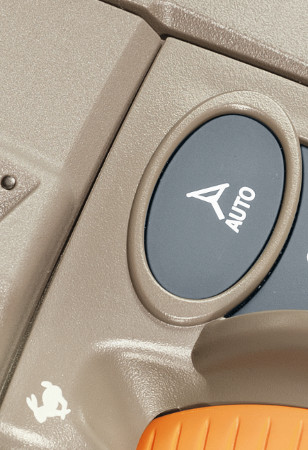 AutoTrac resume switch
AutoTrac resume switch
AutoTrac ready
The 5R Tractors can be equipped with an AutoTrac ready option from factory:
- GreenStar™/ISOBUS ready option
- Wheel angle sensor
- Electrohydraulic steering valve
- Steering wheel sensor
- Harnesses
AutoTrac Complete
AutoTrac Complete is a fully operational AutoTrac package ex-factory.
The 5R Tractors can be equipped with an AutoTrac Complete option from factory:
- AutoTrac ready (see AutroTrac ready section)
- Gen 4 4240 Universal Display
- StarFire 6000 Receiver
- Activation
 StarFire 6000 Receiver
StarFire 6000 Receiver
 4240 Universal Display
4240 Universal Display
NOTE: For more information on additional displays, receivers, and Precision Ag Technology products, refer to Precision Ag Technology product information.
NOTE: To use AutoTrac, a GreenStar display and StarFire receiver is required.
Improved maneuverability through the mid-frame design
Utility tractor users often work in challenging environments, including in and around barns, fields, or livestock areas. Maneuverability is a priority as space can be limited at times. Implementing the single-piece mid-frame design helps improve turning radius.
 Single-piece mid frame
Single-piece mid frame
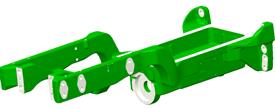 Structural oil pan
Structural oil pan
Command8™ transmission for premium ground speed and load management
Command8 transmission is optional on 5R Tractors
The Command8 transmission expands the proven reliability of the PowrReverser™ transmission with a 4-range, 8-speed transmission that enhances operator convenience and productivity through fully electronic range and gear shifting, as well as automatic shifting capabilities. The Command8 uses the same final drives, rear axle, and differential as the already proven 5M PowrReverser transmissions. Rather than using mechanical synchronizers, the Command8 utilizes powershift clutches. Also, electrohydraulic cylinders move the shift rails instead of a mechanical lever. This provides excellent ease of use and more efficient operation.
The Command8 transmission is equipped with 32 forward and 16 reverse (32F/16R) speeds, a left-hand reverser, and eight powershiftable gears in four fully synchronized ranges. The Command8 transmission also comes with pressure and flow compensating (PFC) hydraulics in base equipment. The Command8 operates at speeds as slow as 1.9 km/h (1.18 mph) with rolling circumference index (RCI) group 44 rear tires, and speeds up to 40 km/h (25 mph).
Operating the Command8 transmission
 Command8 shift controls
Command8 shift controls
Range/gear controls
A single control lever, similar to the control used on the DirectDrive™ transmission on 6R and CommandQuad™ transmission on 7R, features an ergonomically designed and intuitive operator interface. This control lever provides manual gear and range change selection when in the left position, and auto selection when shifted to the right position. The thumbwheel is used to dial in the desired ground speed in the auto position.
Once the tractor is started, the operator selects a range by pressing one of the lettered range buttons on the right hand console. The operator has five different selections to choose from - A, B, C, and two multi-range modes (BCD and CD). When a range with a single letter is selected, gear shifting is allowed within the specified range. When a range with multiple letters is selected, operators can shift between the designated ranges simply by using the toggle lever.
The gear within the range can be selected by using the transmission control toggle lever to electronically shift to a desired gear. After setting the desired throttle position, the operator can move the left-hand reverser to the forward or reverse position to start movement. The operator can shift up or down through the gears in the selected range(s) as needed.
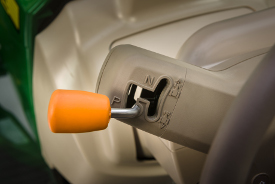 Left-hand reverser
Left-hand reverser
Left-hand reverse
The electronic left-hand reverser is standard with all Command8 transmissions and provides neutral-to-gear modulation, which allows a quick, convenient, and smooth forward-reverse shuttle shifting at any speed. The shifter must be lifted from either park or neutral position to forward or reverse to activate. The parking brake is also electronically controlled through the left-hand reverser.
The left-hand reverser is a great feature for loader tractors. The operator's left hand can control easily tractor direction while the right hand manages the loader joystick and speed changes.
 Command8 in manual mode
Command8 in manual mode
Manual mode
The Command8 features two different ways to operate transmission range and speed selections. In manual mode, the operator has the ability to shift through speeds and ranges without clutching by moving the toggle lever forward, toward the + indicator, or backward, toward the - indicator. A single movement of the toggle lever changes one gear at a time. Holding the toggle lever in either direction increases accelerates gear changes throughout the range at a faster pace.
When in a multi-range mode, a simple double toggle of the lever moves to the next range.
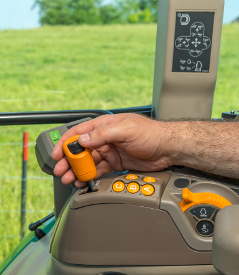 Command8 in auto mode
Command8 in auto mode
AUTO mode
Depending on load, auto mode will optimize both the engine and transmission by selecting the appropriate gear and rpm to optimize fuel efficiency. The only input needed from the operator is to set the target ground speed by using the thumbwheel. Once that target speed is set by the operator, the tractor takes care of maintaining that speed.
Once the operator has selected auto mode with the transmission shift lever, the following items will be displayed on the cornerpost display – auto activation, current ground speed, target ground speed, direction, range, and gear. If the operator has selected auto mode with the transmission control lever, then the operator can set the shift points of the transmission through the cornerpost display.
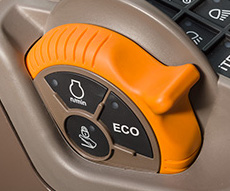 Foot pedal lock switch
Foot pedal lock switch
Foot pedal lock
Similar to cruise control in a car, the foot pedal lock allows the operator to set a constant speed using the foot pedal. The switch to engage foot pedal lock is also located on the right-hand throttle control. To operate the feature, the hand throttle must be on the low throttle position. Use the foot control to increase the tractor to the desired travel speed, and then press the button to engage the foot pedal lock. When releasing the foot throttle, the tractor will then maintain the speed selected. It can be disengaged by either tapping the brakes, or moving the left hand reverser control to neutral or park.
Features available in both manual and AUTO mode
AutoClutch system
With AutoClutch, which is standard on all 5R Utility Tractors, the operator no longer has to use the clutch to control braking and re-engagement of the tractor if so desired. The clutch pedal is still on the tractor for those operators that still prefer to manually foot clutch. This provides the ultimate in ease of use.
AutoClutch allows the operator to bring the tractor to a complete stop without clutching, while at the same time does not overload the engine. It also provides the ability to inch or creep the tractor forward or reverse on a level surface or incline. And it provides the ability to accelerate the vehicle back to normal speed when releasing the brake.
The operator can set the sensitivity setting of the AutoClutch system in the cornerpost display. There are three modes available:
- High sensitivity (default mode)
- Off – temporary setting only that is reset after a key cycle
- Low sensitivity
Low sensitivity would be typically used in transport applications with a towed implement. The low sensitivity ensures that the tractor and implement are stretched for better traction control.
Speed matching
When shifting ranges in a multi-range mode (BCD, CD), the transmission will shift to a gear that most closely matches the speed in the range from which the operator is shifting from, which improves operator comfort by making a smoother transition into a new range. There are two types of speed matching, passive and active.
With passive speed matching, when shifting to a new range, the tractor shifts to a selected fixed gear in the new range based on transmission ratios. For example, when shifting from C8 to D range, instead of shifting into D8 when the range is changed to D like a mechanically controlled transmission would do, the transmission shifts to a preset range and gear of D2. This most closely matches the transmission ratio from which the operator is coming from.
Active speed matching shifts up or down based on wheel speed during range shifts. This minimizes acceleration or deceleration when the clutch re-engages after a range shift and keeps a more consistent ground speed, improving operator comfort.
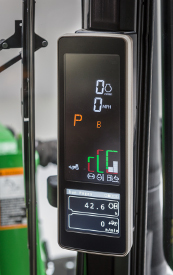 PowrReverser modulation settings in cornerpost display
PowrReverser modulation settings in cornerpost display
PowrReverser modulation
Similar to the 5M Utility Tractors, which offer a PowrReverser modulation dial to set aggressiveness of change in direction, all 5R Utility Tractors also offer PowrReverser modulation. Rather than a physical dial, the aggressiveness can be set through the cornerpost display. Settings can be set from 1 to 10, with 1 being the least aggressive direction change and 10 being the most aggressive direction change. A setting of 10 is popular for loader bucket applications where quicker directional changes are acceptable and more productivity is desired. Less aggressive modulation settings are ideal where smoother directional changes are required, such as bale stacking and pallet fork activities.
Start gear selection
Starting within gear 1 within every range has a negative impact on productivity. To minimize the amount of shifting required by the operator in many applications, start gears can be programmed by the operator when operating in any of the two multi-range modes.
In range CD, any start gear can be programmed into the cornerpost display between C1 and D1. In range BCD, any start gear can be programmed between B1 and D1. Let’s say that an operator programs B8 as the start gear for BCD range. This means that anytime the operator selects BCD mode by pressing that particular range button, the tractor will automatically begin in gear B8. The operator can of course shift to any range and gear between B1 and D8 from there, but the starting point will be what the operator has programmed. This results in less shifting and more productivity.
Within the fixed ranges (A, B, C), the preset start gears are A8, B8, and C4. These cannot be altered by the operator through the cornerpost display.
Independent programmable forward/reverse ratio
This feature is helpful in cyclical operations, such as loader work, where the operator wants to control the forward speed as a ratio of the reverse speed.
In manual mode, the tractor automatically selects a gear closest to the ratio desired by the operator. In auto mode, the tractor would adjust the set speed in the opposite direction. Ratios can be programmed up to 100 percent faster than the forward speed or up to 80 percent slower than the forward speed within the cornerpost display. This is adjustable in 20 percent increments (Forward speed x 0.20, 0.40, 0.60, 0.80, 1.00, 1.20, 1.40, 1.60, 1.80, 2.00).
Another selection is independent; in this mode the tractor remembers the last forward and reverse gear setting. Once the gear is manually changed in the reverse direction, the gear will automatically go back to the last gear when changing directions. If the gear is not manually changed when in reverse direction, then the forward gear and reverse gear will remain the same when changing directions.
While the maximum forward ground speed is 40 km/h (25 mph), the maximum reverse speed is 30 km/h (18.6 mph).
Load anticipation
A load anticipation feature is standard equipment on all tractors equipped with a Command8 transmission. Its primary function is to increase productivity and provide more operator comfort by assisting the operator to handle expected high-load situations by automatically increasing the fuel economy optimal engine speed when working with implements. It can be used in both PTO and hitch activities, and can be turned on or off for each within the cornerpost display.
If turned on through the display, load anticipation is activated when:
- PTO turned on – engine speed automatically increases to the maximum engine speed
- Hitch movement – engine speed automatically increases to 1500 rpm when a hitch movement is detected
The load anticipation feature also activates when using PTO or hitch functions programmed within iTEC™ system sequences.
Features available in auto mode only (Efficiency Manager™ feature)
Efficiency Manager is automatically enabled when the shift lever is placed in the automatic mode gate. The set speed adjuster on the top of the single lever gear selector allows the operator to dial in the desired ground speed to establish a set speed for forward and reverse. Efficiency Manager allows the transmission to up- or down-shift and change engine rpm to maintain the set wheel speed. To reach the desired set speed, the throttle must be set to full engine rpm. This allows Efficiency Manager to shift the transmission and adjust engine speed to maintain the desired wheel speed.
 Eco on / Eco off switch
Eco on / Eco off switch
Eco on / Eco off
In some applications an operator may want to manage parameters for shifting points and minimum engine rpm. This can be accomplished with settings within the cornerpost display via Eco mode. Eco mode can be turned off and on with a switch located on the hand throttle. In many cases, operators will choose to utilize Eco mode in lower load conditions, such as transport. For tough field conditions, Eco mode is typically turned off. Minimum engine speed is adjustable between 900 and 2100 rpm.
Eco mode allows the operator to program two minimum engine speeds, one for when Eco is turned off, and one for when Eco is turned on. When Eco mode is activated, the transmission and engine will shift up and throttle back in order to try to maintain ground speed at the low engine rpm selected by the operator. For example, if a grower chooses a target speed of 12 km/h at an engine speed of 1200 rpm. The transmission and engine will work together to shift to higher gears and throttle back to find a gear that is able to get close to the 1200 rpm target.
When the grower gets to the field and wants to increase engine rpm to handle working tasks, simply turn Eco off with the Eco button on the throttle control, and the transmission and engine will then shift down and throttle up. The tractor will again target the speed selected via the thumbwheel, and the engine rpm that has been programmed into the cornerpost display for Eco off.
This is an excellent way to maximize fuel efficiency on a 5R Utility Tractor.
![Load control droop (power take-off [PTO] on) settings in cornerpost display](https://salesmanual.deere.com/sales/salesmanual/images/NA/tractors/pic_to_come.jpg) Load control droop (power take-off [PTO] on) settings in cornerpost display
Load control droop (power take-off [PTO] on) settings in cornerpost display
Load control droop
Load control droop allows the operator to control the shift point of the tractor. The goal of auto mode is to prevent the engine pulling down below this preselected operating point by downshifting automatically. It commands an upshift so that the engine speed is above the load control set point (droop) with sufficient torque reserve. It also commands a downshift when the engine speed is pulled down below the load control set point (droop). The load control droop can be set within the cornerpost display in two modes, PTO on and PTO off.
The settings the operator can choose from in the cornerpost display are:
- PTO on
- High droop
- Medium droop
- Low droop
- PTO off
- High droop
- Medium droop
- Low droop
Selecting high droop minimizes shifting, while selecting low droop provides faster reaction to load.
Premium cab with high visibility panorama roof for the ultimate operating experience
The premium cab is designed to provide superior visibility for the ultimate operating experience, especially in front loader applications. This cab includes all of the features of the standard cab operator station plus much more. Some of the key features include:
- Panoramic sunroof with sliding top shade and pull down front sunshade
- Factory-installed radio
- Bluetooth® system ready
- Satellite capable
- Deluxe sound system with front-corner-mounted speakers and subwoofer
- USB port (for sound only)
- Auxiliary cord connection
- Additional interior cab light
- Rear windshield wiper
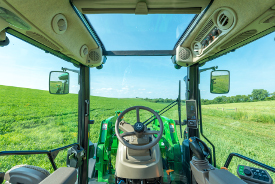 Premium panorama cab
Premium panorama cab
Visibility
Featuring a single-piece front windshield, forward facing visibility has improved by 7 percent for easier loader attachment hookups and easier following of rows in vegetable and other row-crop applications. Upward visibility has improved 80 percent with the panorama roof in the premium cab, providing for easier bale stacking, pallet stacking, and dumping loads into walled trailers.
For improved ease of use and visibility in both sunny and adverse weather conditions, the premium cab comes standard with several tools to help get the job done. To shield the operator from the sun on bright days, an easy-to-use sliding overhead sunshade with an integrated front pull-down shade is provided. To provide additional visibility in adverse conditions, such as rain or fog, the premium cab comes standard with a factory-installed rear window wiper, and exhaust vents built into the back of the front-mounted speakers.
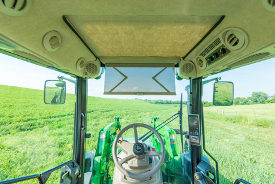 Panoramic sunroof with sliding top shade and pull-down front sunshade
Panoramic sunroof with sliding top shade and pull-down front sunshade
Sound and radio
Standard factory-installed radio is Bluetooth ready and has satellite capability. The premium cab also offers a deluxe sounds system with front-corner- mounted speakers and a subwoofer behind the seat for enhanced sound performance. The satellite radio capability feature makes it easy for operators to connect the sound system to SiriusXM® radio. The premium cab comes with a Bosch® deluxe radio, and offers both an auxiliary and a USB port to connect custom electronic devices. Using the Bluetooth feature, customers are able to connect to their phones to the radio providing wireless connectivity. Integrated into this deluxe sound system is an additional interior cab light in the bottom of the left-corner-mounted speaker.
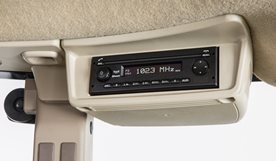 Factory-installed radio
Factory-installed radio
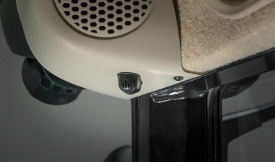 Bluetooth microphone
Bluetooth microphone
 Auxiliary cord connection
Auxiliary cord connection
Bluetooth is a trademark of Bluetooth SIG Incorporated. Bosch is a trademark of Robert Bosch GmbH. Sirius XM is a trademark of Sirius XM Radio Inc.
Loader joysticks with integrated transmission and direction control
Controlling speed and direction of the 5R Tractor in loader applications has never been easier. With the Command8™ transmission, gear shifting and directional change is included as base equipment on any 5R Tractor that is equipped with mid selective control valves (SCVs). Both mechanical and electronic joystick options are mounted to the swivel seat. With a standard swivel seat, anytime the operator moves, the joystick also swivels along with it. This design improves comfort and operational efficiency by always having the loader controls at the operator’s fingertips.
 Mechanical loader joystick
Mechanical loader joystick
There are two types of loader joysticks available, mechanical and electrohydraulic. The boom movement and implement rollback are controlled via cables from the loader joystick, which actuate the mid SCVs. If equipped with a third SCV for grapple functions, electronic buttons on the joystick control the opening and closing of the grapple.
On top of the loader joystick are buttons for gear selection. Pressing the rabbit or turtle buttons will shift the tractor by one gear. If the operator presses and holds the button, the tractor will more quickly accelerate through the gears when in a multi range selection (BCD or CD). Operating a loader tractor has never been easier.
The mechanical joystick can be easily locked out with a simple twist when the loader is not in use. Loader suspension can also be turned on and off on the face of the joystick with a switch.
 Electrohydraulic loader joystick
Electrohydraulic loader joystick
The electrohydraulic joystick is very similar to the mechanical joystick, but with a few key differences. This joystick also swivels with the seat, but is mounted at the end of the armrest rather than the seat base. Instead of cable control of the SCVs, it is fully electronic. The lockout is controlled electronically rather than with a mechanical lock. It is also available only with pressure-and-flow compensated (PFC) hydraulics. The functionality is very similar to that of the mechanical joystick.
Either joystick option makes loader operation extremely comfortable on those long days of moving hay bales, stacking pallets, or general loader work.
NOTE: Electrohydraulic loader joystick is the only joystick compatible with the CommandARM™ console.
Loader joysticks with integrated reverser
Controlling direction on the 5R Tractor in loader applications has never been easier. With the Command8 transmission, the integrated joystick reverser is included as base equipment on any 5R Tractor that is equipped with mid SCVs.
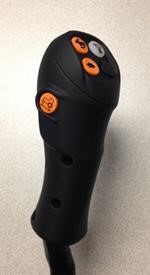 Reverser on mechanical loader joystick
Reverser on mechanical loader joystick
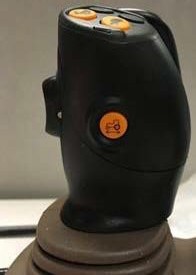 Reverser on electrohydraulic loader joystick
Reverser on electrohydraulic loader joystick
The two types of loader joysticks available, mechanical and electrohydraulic, are both equipped with the reverser functionality.
On the side of the loader joystick is a button for reverser function. By pressing the button, the tractor will change direction.
This joystick reverser feature makes loader operation extremely comfortable on those long days of moving hay bales, stacking pallets, or general loader work.
Optional CommandARM™
Take command of the 5R Tractor with the optional CommandARM console. Bring the functionality of selective control valves (SCVs), power take-off (PTO) engagement, hitch adjustment, and loader controls to one common place while still having the functionality to swivel the seat. Integrating large tractor technology into the 5R Series, operators will notice common features such as easily identifiable SCVs with color coding as well as the PTO engagement switch.
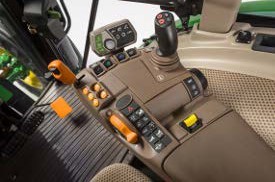 CommandARM console
CommandARM console
CommandARM provides individual access to the most frequently used controls.
- Engine throttle
- Transmission controls
- Electrohydraulic PTO
- Hitch/SCV controls (up to four rear SCV’s)
- Primary display unit (PDM)
- Loader joystick
Standard AutoClutch™ system for clutchless operation
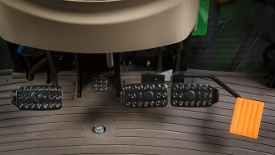 Brake pedals
Brake pedals
With AutoClutch, which is standard on all 5R Utility Tractors, the operator no longer has to use the clutch to control braking and re-engagement of the tractor if so desired. The clutch pedal is still on the tractor for those operators that still prefer to manually foot clutch. This provides the ultimate in ease of use, especially in applications where precise control and more stopping /starting is required.
AutoClutch allows the operator to bring the tractor to a complete stop without clutching, while at the same time does not overload the engine. It also provides the ability to inch or creep the tractor forward or reverse on a level surface or incline. Being able to inch or creep the tractor is an important tool for more efficient front and rear implement hookups. AutoClutch also provides the ability to accelerate the vehicle back to normal speed when releasing the brake.
 AutoClutch settings in cornerpost display
AutoClutch settings in cornerpost display
The operator can set the sensitivity setting of the AutoClutch system in the cornerpost display. There are three modes available:
- High sensitivity (default mode)
- Medium sensitivity
- Low sensitivity
- Off – temporary setting only that is reset after a key cycle
Low sensitivity would be typically used in transport applications with a towed implement. The low sensitivity ensures that the tractor and implement are stretched for better traction control.
Maximum fluid efficiency with Final Tier 4 (FT4) engines
The U.S. Environmental Protection Agency Agency (EPA) and Environment Canada requires all off-road diesel engines with 18.6 kW (25 hp) or more to meet stringent FT4 emissions regulations. John Deere uses the most efficient and cost-effective solution for the tractor package to meet emissions requirements at each horsepower level.
The engine powering the 5R is EPA certified Tier Level 4. This is achieved through a combination of a diesel oxidation catalyst (DOC) and selective catalytic reduction (SCR) using diesel exhaust fluid (DEF, or urea).
Several defining features on the 5R maximize the performance and reliability of the emissions package. A completely shielded DOC/SCR not only protects essential components from damage, it also keeps out dirt and debris. The well-packaged and tightly organized circulation system means there is more room to work around the tractor.
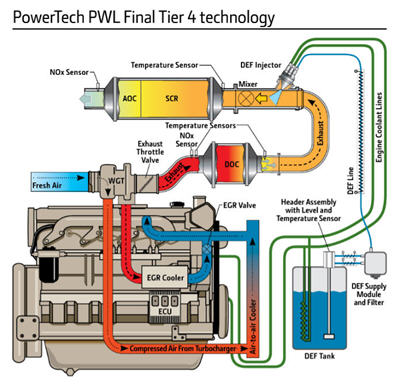 PowerTech™ PWL Final Tier 4 technology
PowerTech™ PWL Final Tier 4 technology
Key components of the emissions system include:
DOC
John Deere has chosen to utilize an DOC to reduce NOx to create less particulate matter. By no longer including a diesel particulate filter (DPF) and increased efficiencies in other areas of the tractor, the result is improved total fluid economy (diesel and DEF) and a lower cost to the producer.
The engine is programmed to aggressively respond to changes in power needs, which can temporarily increase particulate matter. Since the DOC removes particulate matter instead of the engine, the engine is left free to do what it is designed to do – deliver all of the power, torque, plus transient response needed.
DEF
DEF is an ISO 22241 standard aqueous urea solution consisting of 32.5 percent urea and has a freezing point of -11°C (12°F). A 11.4-L (3-gal.) heated DEF tank used in conjunction with a 143.8-L (38-gal.) fuel tank keeps the operator in the field longer. A DEF tank heater is integrated with a temperature sensor, and plumbed engine coolant lines are used to promote thawing and prevent freezing in the tank during cold operation.
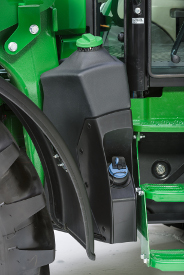 DEF tank
DEF tank
The electronic control unit (ECU) controlled supply module draws DEF from the storage tank 11.4 L (3-gal.) and provides a pressurized flow to the dosing module. When the ignition key is off, the supply module pump will reverse direction to return any accumulated fluid back to the tank. The supply module is also fitted with a replaceable filter to prevent contaminants from entering the dosing lines. Both the supply module and dosing lines are electrically heated and controlled by the ECU to determine when DEF dosing can begin.
The dosing module is cooled by engine coolant and used to inject DEF at a pressure of 130 psi (900 kPa, 9 bar) into the decomposition tube. A harness is connected to the dosing valve that relays the needed DEF to inject based upon the amount of NOx exiting the DOC measured from the NOx tube sensor.
The decomposition tube is the internal mixing device used to circulate DEF with engine exhaust prior to entering the SCR/AOC after-treatment device.
SCR
To reduce the NOx, DEF is injected into the exhaust stream. When the exhaust gases combine with the DEF in the SCR catalyst, the NOx is broken down into nitrogen and water vapor.
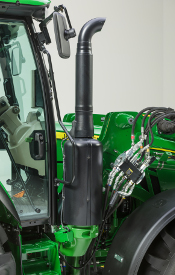 SCR location on the 5R Tractor
SCR location on the 5R Tractor
Benefits of air-to-air aftercooling
- Lowers the intake manifold air temperature
- Provides more efficient cooling while reducing temperatures for greater engine reliability
- Higher volume of air flows into the cylinders
- Engine is capable of meeting the increasing horsepower demands
Exhaust gas recirculation (EGR)
EGR reduces the high temperatures where these compounds are formed in the engine cylinders by replacing excess oxygen with a prescribed amount of cooled exhaust gas.
Exhaust gases contain more carbon dioxide than oxygen. The EGR valve, in conjunction with the venturi tube, and engine control unit (ECU), allow a controlled amount of exhaust gas to enter the intake manifold to mix with the incoming fresh air.
Replacing excess oxygen with cooled exhaust gas leads to:
- Lower combustion temperatures, creating less NOx.
In addition, EGR allows for:
- Advanced timing
- Optimal engine performance
- Maximum fuel economy
For added performance and efficiency, the engine passes the exhaust gases through an EGR cooler before it enters the engine.
Exhaust airflow enters into the EGR cooler from the exhaust manifold near the turbocharger. Based on engine load, air temperatures, and rpm, the ECU opens or closes the EGR valve, allowing a measured percentage of exhaust gas to enter the intake manifold. The gases mix with the rest of the incoming air from the turbocharger and aftercooler before entering the cylinders.
Turbocharged engine
The PowerTech PWL 4.5L utilizes one turbocharger — a fixed geometry, wastegate turbocharger. Fresh air is first drawn into the low-pressure fixed geometry, wastegate turbocharger, and compressed to a higher pressure. The compressed air is then routed to the charge air cooler and then to the intake manifold.
Combustion process with externally cooled EGR
Functions:
- According to engine operating conditions, the recirculated exhaust gases reduce the oxygen portion in the intake air to approximately 20 percent. Without any increase of the charge air pressure, the oxygen rate is not high enough to ensure a complete combustion of the fuel injected at high engine loads.
Advantages:
- Fuel-efficient combustion is achieved, because sufficient oxygen is provided.
A restrained, cooler combustion is realized, since the typical hot combustion process, which is generated by an oxygen surplus, is dampened by the inert exhaust gases. Hence, NOx emissions are reduced.
For more information regarding EPA regulations and the technology behind John Deere Integrated Emissions Control systems, please visit the following link:
http://www.deere.com/wps/dcom/en_US/campaigns/ag_turf/emissions/final_tier_4.page
Power bulge and torque reserve pull through the tough spots
Putting more power to the ground translates to increased productivity in demanding conditions. Simply put, torque is the useable power that can be achieved. More torque leads to more lugging ability which helps the operator be more productive.
5R Final Tier 4 (FT4) engines feature up to an 8 percent power bulge when put under load. The power bulge feature of the electronically controlled engine delivers additional horsepower as engine rpm drops below rated speed. Additionally, a 36 percent torque rise provides the force that maintains horsepower as engine rpm drops below rated speed.
When the tractor is under load, power bulge and torque rise work together to get through the tough spots and reduce the need to downshift. Horsepower and torque are mathematically related.
 |
As rpm drops, the only way to maintain or increase horsepower is to provide additional torque. The output horsepower is greater than or equal to rated horsepower as the engine is pulled down to 1750 rpm.
The peak torque rise also occurs near the rated economy power take-off (EPTO) speed for enhanced performance when operating in 540E power take-off (PTO).
NOTE: 5RH – 5115 hp only.
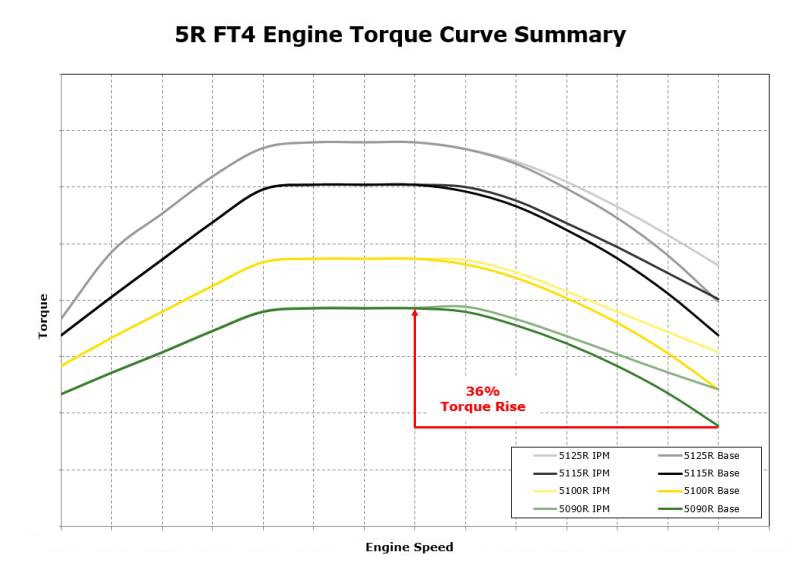 5R torque curve summary
5R torque curve summary
 5R engine power curve summary
5R engine power curve summary
Intuitive digital cornerpost display
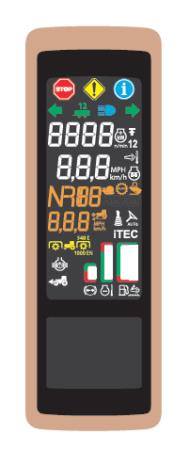 Digital cornerpost display
Digital cornerpost display
The digital cornerpost display features state-of-the-art electronic instrumentation and blends well with the narrow right-hand cab post. This intuitive design eliminates the instrument cluster once surrounding the steering column while increasing forward facing visibility. In addition to displaying machine information, the cornerpost display also serves as the primary interface between the tractor and operator when adjusting hitch, transmission, hydraulic, and engine settings.
Information included in the display:
- Stop, service, and information alerts
- Exhaust filter cleaning indicator
- Engine rpm (engine speed)
- Fuel-level gauge with low-fuel warning
- Diesel exhaust fluid (DEF) level indicator
- Engine temperature gauge
- Power take-off (PTO) engaged indicator
- Range information (F, N, R, P), transmission range and gear indicator
- Gear and AUTO mode indication
- Ground speed
- Target speed (in AUTO mode)
- Field cruise
- Differential lock indicator
- Mechanical front-wheel drive (MFWD) indicator
- Turn signal and hazard indicators
- High-beam indicators
- Start aid time remaining (with electric air intake heater)
- Creeper indication (if equipped)
- iTEC™ system indication (if equipped)
 Cornerpost display interface
Cornerpost display interface
Interaction with the cornerpost display is primarily controlled with a button module mounted at the front of the right-hand upholstery. On the left side in green are a check mark button used to select items, a left arrow button that serves as a back button, and a menu button. The black wheel in the center is used for toggling within screens or adjusting settings.
To the right of the scroll wheel are hot buttons for frequently controlled settings, including draft control, hitch raise height, hitch drop rate, engine settings, transmission settings, and hydraulic settings. These buttons serve as shortcuts to make adjusting more common settings quicker and easier to access.
Features
Low-profile standard open operator station (OOS)
The standard OOS on 5ML Tractors was designed for low-clearance applications. It features a low-profile seat, a smaller-diameter steering wheel, protected controls, and a low-profile, rear-mounted rollover protective structure (ROPS). Combined with the sloping hood, this is beneficial to the operator’s visibility to the front of the tractor. Rounding off these standard features and incorporated into each operator platform is a shield which limits heat transfer from the hydraulics to the operator.
All of the most crucial operator controls are conveniently located within arms’ reach on the right-hand console control pod. The engine throttle control, selective control valve (SCV) levers, power take-off (PTO) engagement, and hitch-lift control levers are grouped together. On the 5ML, this control pod is positioned on the right-side fender, protected from low-hanging crops by a shield.
 Right-hand fender shield and low profile seat
Right-hand fender shield and low profile seat
Color-coded bands on the SCV levers correspond with the color on the rear SCVs, making it easy for any operator to determine which lever operates which rear SCV.
The 5ML Tractor also offers optional fender extensions to minimize crop disturbance, especially in orchards or tree nut applications. Two fender extension options are available to meet varying tire sizes and coverage preferences.
The foldable ROPS on the 5ML Tractor has a unique design and is 15.2-cm (6-in.) lower at maximum height than the standard 5M Tractors.
The shifter linkages are tighter to offer a more accurate shift pattern, which translates to a crisper throw between gears. Incorporating technology found on standard 5M Tractors, the 5ML now offers a declutch button, enabling the operator to shift gears within a range without the use of the foot clutch.
Dash details:
- Cluster
- Controls
- Steering wheel
5ML Tractors also include the following features:
- Retractable seat belts
- Rear certified ROPS for OOS tractors
- Heat shield limiting hydraulic heat passed onto the operator
- Key-switch interlock prevents bypass starting
- Audible and visual PTO warning alerts when the operator leaves the seat with the PTO engaged
- Positive park position prevents the tractor from moving when the engine is off
- Four amber turn-signal/flashing warning lights for road transport (these are break-away)
- Slow-moving vehicle (SMV) sign alerts other road users during transport
- Safety decals keep safety in the minds of new and experienced operators
- Left- and right-hand steps provide easy and convenient access from both sides of the tractor
- Fuel system is fully grounded to meet safety and fuel fill regulation requirements
- For convenience of operation, the fuel and diesel exhaust fluid (DEF) fill are both on the same side with clearly marked and color coded caps. The DEF tank has a capacity of 12.1-L (3.2 gal.), which is more than enough to sustain proper tractor operation and fuel treatment for more than one full tank of diesel. A field-installed lockable fuel cap is offered for protection and peace of mind.
Transmission controls on PowrReverser™ transmission models:
Gear and range shift levers are located to the right of the operator. The gear lever incorporates a declutch button enabling the operator to shift gears without the use of the foot clutch. Unique knobs also make it easier to distinguish between the two.
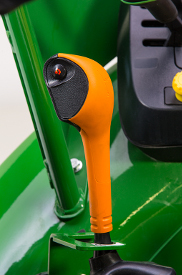 Gear lever with declutch button
Gear lever with declutch button
Transmission controls on PowrQuad™ transmission models:
A single transmission control is located to the right of the operator. This control features the ability to shift through gears within a range using the rabbit button to increase gears and the turtle button to decrease gears. A range change can be completed with this control, as well by moving through A-D ranges similar to a traditional range controller. To aide in ease of operation, operators can use the integrated declutch button rather than the foot clutch to change ranges.
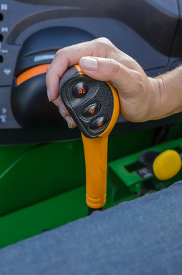 Transmission control on PowrQuad transmission models
Transmission control on PowrQuad transmission models
A foot throttle with a platform pedal is located on the right side of the operator. The pedal is positioned for ease of use, yet does not clutter the floor. The hand throttle is easily accessible on the right hand console.
Engaged by either foot, the differential lock pedal is placed on the floor.
 Differential lock button
Differential lock button
When the tractor is used in applications requiring the clutch and brake pedals to be used frequently, the operator will see the benefit of the suspended pedals.
The electrohydraulic forward/reverse direction lever is located on the left-hand side of the instrument console, connected to the steering column. There is also a guard for the reverser lever. Operated with the left-hand finger, the right hand is free to simultaneously run the loader, hitch, or hand throttle.
 Left hand reverser with guard
Left hand reverser with guard
3-point hitch controls
Mechanical hitch controls are available on models equipped with a PowrReverser transmission, while models equipped with a PowrQuad transmission will have an electrohydraulic (EH) hitch. With an EH hitch, operators will have the functionality to raise and lower the hitch from the rear left-hand fender, reducing time when attaching and detaching implements.
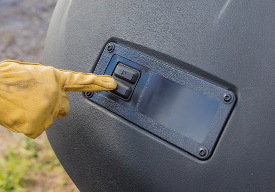 Left-hand fender hitch control
Left-hand fender hitch control
PTO controls and speeds
The 5ML features electrohydraulic PTO engagement on all models.
The push/pull knob on open station tractors is conveniently located beside the hand throttle on the right-hand side of the operator. When the PTO is engaged, a light on the instrument panel will illuminate and PTO speed is indicated by target bars. Models equipped with a PowrReverser transmission have a 540/540E rpm shiftable PTO while models equipped with a PowrQuad transmission have a three-speed PTO, 540/540E/1000 rpm.
Enhancing operator safety, the tractor does not start with the PTO engaged. An alarm sounds if the operator attempts to leave the seat with the PTO engaged. The PTO shaft is protected by a hinged shield.
Hydraulics controls
The color-coded bands on the levers, which control triple rear SCVs, correspond to the color of the dust cap and the SCV valve they control.
Mechanical front-wheel drive (MFWD) controls
All four-wheel drive (4WD) axles are equipped with the engage-on-the-go MFWD. This toggle switch is now located on the right-hand console.
Lighting controls – Multi-position dial
The five-position lighting package is straightforward with the lighting control switch on the right side of the steering column. The switch positions are: off, warning, work light, transport 1 (warning and high-beam headlights), and transport 2 (warning and headlights). A turn-signal lever is located on the left side of the steering column for quick and easy use.
Power bulge and torque reserve pull through the tough spots
5M Final Tier 4 (FT4) engines feature up to a 4 percent power bulge when put under load. The power bulge feature of the electronically controlled engine delivers additional horsepower as engine rpm drops below rated speed. Additionally, a 30 percent torque rise provides the force that maintains horsepower as engine rpm drops below rated speed.
When the tractor is under load, power bulge and torque rise work together to get through the tough spots without having to downshift. Horsepower and torque are mathematically related.
 |
As rpm drops, the only way to maintain or increase horsepower is to provide additional torque. The output horsepower is greater than or equal to rated horsepower as the engine is pulled down to 1750 rpm.
The peak torque rise also occurs near the rated economy power take-off (EPTO) speed.
 5ML power curve summary
5ML power curve summary
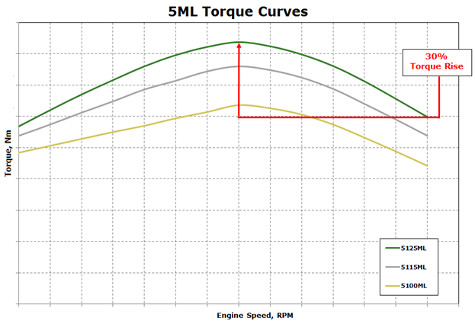 5ML torque curve summary
5ML torque curve summary
PowrQuad™ transmissions
The PowrQuad™ transmission can be ordered on any of the 5ML Tractor models with three different options to meet producer needs: 16F/16R PowrQuad, 16F/16R PowrQuad with creeper, or 32F/16R Power 8. These three transmissions options come standard with a 540/540 Economy/1000 power take-off (PTO) and are compatible with the pressure-and-flow compensated (PFC) hydraulic system.
Pairing a PowrQuad or a Power 8 transmission with PFC hydraulics provides more hydraulic flow, increased hitch lift capacity over PowrReverser models, and an electrohydraulic (EH) hitch control for repeatable hitch movements.
The ergonomically placed transmission control allows the operator to change gears and ranging with one simple control. Two buttons, a rabbit or turtle indicator, allow one to gear up (rabbit) or gear down (turtle) within a range. A range change can be made with a simple press of the declutch button rather than using the foot clutch. If preferred, the foot clutch remains incorporated into the operator station for use.
 Integrated declutch and gear buttons on transmission control
Integrated declutch and gear buttons on transmission control
Ranges on the transmission control can be selected by moving the controller in an H pattern. The lever selects ranges A, B, C, or D. Ranges C and D are fully synchronized. That means, when upshifting, operators can move from range C to D without stopping the tractor. On the downshift, operators can move from D all the way to B without stopping.
Maximum productivity is achieved with clutchless hydraulic shifting between forward and reverse and is ideal for loader work and any other applications that require frequent directional changes in tight spaces. An electrohydraulic fingertip directional lever control allows the operator to effortlessly switch directions with a small finger motion.
This control is located on the left side of the instrument console and selects forward, reverse, and neutral positions. It also allows the operator to steer and shift direction with the left hand, freeing the right hand to operate other tractor controls, such as the loader, rear implements, or hand throttle.
NOTE: A neutral start switch requires the directional lever be in the neutral position to start the engine.
PowrQuad transmissions include:
- Wet clutch
- Ergonomically mounted transmission lever controlling both gear and range changes
- Declutch button on the range lever
- Left-hand reverser
- Constant-mesh, helical-cut gears
- Pressure-lubricated top shaft
- Positive park pawl
- Three-speed PTO
- Neutral start switch
Reversible stub shaft
All 5ML Tractors equipped with a PowrQuad or Power 8 transmission have a reversible stub shaft with six splines and 21 splines (38 mm [1.5 in.]). To switch between 540 and 1000 speeds, simply remove the snap ring, flip the PTO shaft, and reinstall the snap ring. The tractor PTO operates at 540-rpm speed when the six-spline end of the shaft is visible, and at 1000 speed when the 21-spline end of the shaft is visible.
The reversible 540/ 540E/1000 PTO stub shaft is located in a dry cavity to allow changing from 540/540E rpm to 1000 rpm or vice versa without any oil spillage. This interchangeability allows the matching of different implements. The reversible stub shaft improves uptime as no bolts are needed for removal, just a simple snap ring.
 |
 |
A = snap ring B = snap ring groove C = bore |
| Reversible stub shaft (six and 21 splines) | ||
NOTE: See PTO functional area for more information on economy PTO.
Features
Tailor-made to fit many applications
 5090EL Tractor
5090EL Tractor
Leveraging the proven 5E 4-cylinder platform, the 5090EL Tractor is suited to fit in confined spaces where clearance is a constraint. While this model is of special interest to poultry farmers, it has the power to tackle other jobs with various implements.
Special adjustments were made to accommodate low clearance applications. By lowering the rollover protective structure (ROPS) hinge point, operators will be able to reduce the overall tractor height, enabling them to stay below overhead obstacles. Adding to the possibility for low clearance, a factory-installed side exhaust is offered with the 5090EL Tractor. Lastly, updated tire options are available to suit the application. Regardless of tire selection, fenders can be adjusted to accommodate producer preference while optional additional fenders can be added to provide ample coverage to protect operators from mud and debris.
Torque reserve for powering through tough spots
 |
 4-cylinder 5E torque curve summary
4-cylinder 5E torque curve summary
24F/12R PowrReverser™ transmission for more speed selection variety
This PowrReverser transmission provides 24 forward speeds and 12 reverse (24F/12R) speeds. Included in base equipment is a dual speed 540/540 Economy power take-off (PTO), and it is ideal for applications requiring frequent directional changes, such as loader work and PTO work like rotary cutting and baling hay.
Hydraulic wet forward and reverse clutches maximize durability and outlast the life of any dry clutch. When tractors are run by multiple operators with a variety of experience levels, a wet clutch is the best way to maintain transmission integrity and performance while decreasing clutch replacement costs.
Two platform-mounted levers offer easy and comfortable shifting. To distinguish the two levers for ease of operation, the gear-shift lever is longer and the less-used range lever is shorter. Unique knobs make it easy to distinguish between the two just by feel.
The hi/lo selector buttons are located on the gear shift lever for each forward gear, and are represented by a rabbit and a turtle respectively.
The forward lever selects one of four gears. All are synchronized for on-the-go shifting with the use of the clutch. The rear lever selects one of three ranges: A, B, or C.
Maximum productivity is achieved with clutch-less hydraulic shifting between forward and reverse. PowrReverser functionality is ideal for rear blading and any applications that require frequent directional changes in tight spaces. An electrohydraulic fingertip directional lever control allows the operator to effortlessly switch directions with a small finger motion. The control is located on the left side of the instrument console and selects forward, reverse, and neutral positions. It also allows the operator to steer and shift direction with the left hand, freeing the right hand to operate other tractor controls, such as the loader, rear implements, or hand throttle. The PowrReverser has a built-in engagement override valve for additional safety. This valve requires the clutch pedal to be depressed one time after each engine start before the transmission will begin to operate normally, giving the operator another opportunity to put all focus on the tractor.
A neutral start switch requires the directional lever be in the neutral position to start the engine.
 Left-hand reverser lever
Left-hand reverser lever
The speed of directional changes can be adjusted to the operator's preference or application demands with an optional field installed infinitely variable control kit.
24F/12R transmission includes:
- Wet clutch
- Platform-mounted shift levers with four gears (with hi/lo selector in forward) and three ranges
- Left-hand reverser
- Constant-mesh helical-cut gears
- Pressure-lubricated top shaft
- Positive park pawl
- Neutral start switch
All tractors have economy PTO (E-PTO), a fuel-saving feature which allows customers to operate rear implements at 540 PTO rpm but at lower engine rpm. The result is lower engine vibration, reduced noise, less wear and tear on the engine, reduced fuel consumption and increased operator comfort.
See the PTO functional area for more information on E-PTO.
12F/12R PowrReverser™ transmission
The 12F/12R PowrReverser transmission provides ample speeds and ease of operation. This transmission comes standard with a dual speed 540/540 economy power take-off (E-PTO) and is ideal for applications requiring frequent directional changes such as loader work.
Hydraulic wet clutches (forward and reverse) maximize durability and outlast the life of any dry clutch. When tractors are run by multiple operators with a variety of experience levels, a wet clutch is the best way to maintain transmission integrity and performance while decreasing clutch replacement costs.
Two platform-mounted levers offer easy and comfortable shifting for a pleasant operator experience. The gear-shift lever is easy to reach and the less-used range lever is shorter. Unique knobs make it easy to distinguish between the two.
The forward lever selects one of four gears. The operator must depress the clutch while shifting. The rear lever selects one of three ranges: A, B, or C.
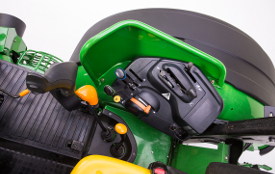 Gear and range shift levers
Gear and range shift levers
Maximum productivity is achieved with clutch-less hydraulic shifting between forward and reverse. PowrReverser functionality is ideal for rear blading and any applications that require frequent directional changes in tight spaces. An electrohydraulic fingertip directional lever control allows the operator to effortlessly switch directions with a small finger motion. The control is located on the left side of the instrument console and selects forward, reverse, and neutral positions. It also allows the operator to steer and shift direction with the left hand, freeing the right hand to operate other tractor controls, such as the loader, rear implements, or hand throttle. The PowrReverser has a built-in engagement override valve for additional safety. This valve requires the clutch pedal to be depressed one time after each engine start before the transmission will begin to operate normally, giving the operator another opportunity to put all focus on the tractor.
NOTE: A neutral start switch requires the directional lever be in the neutral position to start the engine.
 Left-hand reverser lever
Left-hand reverser lever
The speed of directional changes can be adjusted to the operator's preference or application demands with the field-installed infinitely variable control kit.
12F/12R transmission includes:
- Wet clutch
- Platform-mounted shift levers (four gears, three ranges)
- Left-hand reverser
- Constant-mesh helical-cut gears
- Pressure-lubricated top shaft
- Positive park pawl
- Neutral start switch
All tractors have economy PTO (E-PTO), a fuel-saving feature which allows operators to run rear implements at 540 PTO rpm but at lower engine rpm. The result is lower engine vibration, reduced noise, less wear and tear on the engine, reduced fuel consumption, and increased operator comfort.
See the PTO functional area for more information on E-PTO.
540/1000 power take-off (PTO) rpm kit for implement versatility
Producer needs drive John Deere to deliver distinctive value in product solutions. The applications in which John Deere utility tractors, implements, and attachments are used are growing by the day. A 540/1000 PTO rpm field-installed kit is available for the 5E Tractors. With this kit installed, operators can switch between standard 540 or 1000 PTO rpm based on the requirements of the implement. From rotary cutting, to shredding to snow throwing and baling, the capability to operate an implement requiring 1000 rear PTO rpm is available.
Once installation is complete, this solution offers the convenience of switching between 540 and 1000 PTO rpm with relative ease. Combined with the dry sump design, this attachment includes a reversible shaft. This provides for a less mess, no stress option that will enhance customer productivity and increase uptime.
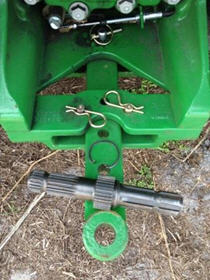 540/1000 PTO rpm field-installed kit
540/1000 PTO rpm field-installed kit
Features
Tailored to fit: John Deere specialty solutions
The 5G Final Tier 4 (FT4) Specialty Series now brings a narrow, ultra-narrow, and low-profile option to specialty applications.
The 5GV Series is built to operate in vineyards with a minimum working width of 108.8 cm (42.8 in.) from rear tire to rear tire. The 5GV Series cab, with an overall width of 108.1 cm (42.6 in.), is designed to pass between narrow vineyard rows. The 5GN features an extra- wide cab of 127.5 cm (50.2 in.). The 5GL series is manufactured with orchardists in mind. This low-profile tractor has an approximate height of 135.89cm (53.5 in.) and width of 152.4cm (60 in.) (depending on tire configuration), which makes it ideal for operating in orchards that are laden with heavy fruit.
The two-door cab on the 5GN and 5GV models offers the operator yet another convenience of entering and exiting from either side. With a distance of 560 mm (22.1 in.) between the right- and left-hand side consoles and a play of 285 mm (11.2 in.) between seat and steering wheel, the 5G Series provides one of the roomiest cabs in the specialty tractor market.
Overview of minimum working widths
 Overview of minimum working widths
Overview of minimum working widths
5G Specialty Series basic feature overview:
| Feature overview | 5GN | 5GV | 5GL |
| 100 hp (74 kW), 4-cylinder / 3.4 L (0.9 gal.) | 5100GN | N/A | N/A |
| 90 hp (63 kW), 4-cylinder / 3.4 L (0.9 gal.) | 5090GN | 5090GV | N/A |
| 75 hp (55 kW), 4-cylinder / 3.4 L (0.9 gal.) | 5075GN | 5075GV | 5075GL |
| Two-wheel drive (2WD) / four-wheel drive (4WD) | Only 4WD | Only 4WD | Only 4WD |
| Cab / open operator station (OOS) | Available | Available | Only OOS |
 5GV cab on 5GN Tractor
5GV cab on 5GN Tractor
The 5G Series has also expanded its platform offerings to include a 5GV cab on a 5GN Tractor. This option combines the fit of 5GV with the wider stance of a 5GN, providing excellent stability paired with the narrowest cab offering available in the 5G portfolio.

John Deere value
Performance: tailored to fit – matching narrow widths and low heights to producers’ high value crop applications.
Auxiliary fuel tank (5GN)
The 5GN models have an optional auxiliary fuel tank available, which increases the fuel tank capacity by up to 38 percent on the 5075GN and up to 33 percent on the 5090GN and 5100GN.
The increased capacity allows for more productive time in the field with fewer stops for refueling.
| Machine | Code | Fuel tank capacity | Code | Auxiliary tank capacity |
| 5075GN | Base | 86 L (22.7 gal.) | 8313 | 28.4 L (7.5 gal.) |
| 5090GN | Base | 73 L (19.3 gal.) | 8313 | 28.4 L (7.5 gal.) |
| 5100GN | Base | 73 L (19.3 gal.) | 8313 | 28.4 L (7.5 gal.) |
 Auxiliary fuel tank
Auxiliary fuel tank
Powerful Final Tier 4 (FT4) engines
The 5G Specialty Series Tractors are equipped with powerful FT4 diesel engines.
All GN, GV, and GL models are equipped with a robust FPT Industrial 4-cylinder, 3.4-L (207.5-cu in.) displacement engine that offers real versatility and performance for all kinds of specialty operations.
| Engine overview | 5GN | 5GV | 5GL |
| 74.6 kW (100 hp), 4-cylinder / 3.4 L (207.5 cu in.) | 5100GN | Not available | Not available |
| 67.1 kW (90 hp), 4-cylinder / 3.4 L (207.5 cu in.) | 5090GN | 5090GV | Not available |
| 55.9 kW (75 hp), 4-cylinder / 3.4 L (207.5 cu in.) | 5075GN | 5075GV | 5075GL |
Supporting the narrow dimensions of the 5GV Series
The narrow width of the 5GV Series requires a compact engine solution. The compact 3.4-L (207.5-cu in.) engine supports the envelope of the 5GV Series entering super narrow vineyards as well as the turning radius at the end of a row.
Performance - made to measure
The engine ensures high productivity under tough working conditions. With a torque of 401 Nm (295.7 lb-ft) for the 74.6-kW (100-hp) model, the engine ensures the optimal performance for versatile operations.
John Deere value:
Performance: the powerful FT4 engines support the narrow machine envelope of the 5G Specialty Series and offer a high torque at rated rpm, which provides a high performance.
Heavy-duty weight
The 5G Series Tractors are heavy-duty utility tractors in two narrow chassis widths. Heavier gross vehicle weight means more down force to keep implements in the ground. Heavier equipment also leads to improved traction and performance in the field. The 5G Series Tractors have the weight to power through tough jobs.
| Machine | Four-wheel drive (4WD) rollover protective structure (ROPS) | 4WD cab |
| 5075GV | 2530 kg (5577 lb) | 2745 kg (6051 lb) |
| 5090GV | 2530 kg (5577 lb) | 2745 kg (6051 lb) |
| 5075GN | 2660 kg (5864 lb) | 2975 kg (6558 lb) |
| 5090GN | 2660 kg (5864 lb) | 2975 kg (6558 lb) |
| 5100GN | 2660 kg (5864 lb) | 2975 kg (6558 lb) |
| 5075GL | 2670 kg (5886 lb) | No cab option |
Excellent serviceability reduces operational costs and improves productivity
Regular service and maintenance are essential to the performance, productivity, and longevity of the tractor.
- Easy access to regular service points minimizes service time.
- Tractors are equipped with onboard self-diagnostic capabilities and are fully compatible with the John Deere-exclusive Service ADVISOR™ system.
- Daily service requirements are minimal and simple to accomplish. Most service interval requirements can be performed with a basic understanding of procedures and common tools.
All items in the daily service schedule can be performed without the use of tools:
- Convenient access to engine oil, hydraulic oil, coolant level, and water separator
- Easy access to periodic engine maintenance checks by simply raising the hood
- Single-point latch mechanism and self-contained leash ensure easy hood opening and closure
NOTE: Always refer to the operator’s manual for complete maintenance and service recommendations.
Outstanding hydraulic performance
The John Deere 5G Series provides an outstanding total hydraulic system flow of 126.4 L/min (33.4 gpm) with an optional third hydraulic pump.
This hydraulic system ensures excellent hydraulic performance and capacity:
- Precise steering without diverting oil flow from the selective control valves (SCVs) and rockshaft is ideal when maneuvering and operating an implement at the same time as turning at the headland
- Ensures easy power steering with heavy loads on the front of the tractor
- Supplies plenty of power to run hydraulic motors
- Fast cycle times even during the simultaneous usage of various hydraulic driven implements
Hydraulic performance |
5075GV | 5090GV | 5075GN | 5090GN | 5100GN | 5075GL |
| Steering and transmission | 29.9 L/min (7.9 gpm) | |||||
| Second pump - SCV and hitch | 66.6 L/min (17.6 gpm) | |||||
| Third pump - rockshaft | 29.9 L/min (7.9 gpm) | |||||
| Total hydraulic flow | 126.4 L/min (33.4 gpm) | |||||
Versatile rear hitch
The heavy-duty 3-point hitch design on the 5G Series provides a standard maximum lift of 2590 kg (5,710 lb) at the ball ends. An optional additional lift cylinder is available for the 5GN Series, which increases the maximum lift capacity by 510 kg (1,124 lb) to 3100 kg (6,834 lb) at the ball ends.
Hooking up implements is quick and simple with the standard Category 2 3-point hitch on the 5GN. Hooking up implements that require Category 1 or Category 1N is also possible and requires very little time with the 5GV and 5GL.
 Optional extra lift capacity shown on the 5GN photo
Optional extra lift capacity shown on the 5GN photo
| Code | Description | Information | Availability |
| 8490 | Additional lift cylinder | Includes additional lift cylinder (maximum lift capacity at ball ends: 3100 kg [6,834 lb]) | 5GN |
| 4130 | Fixed ball ends | 3-point hitch with fixed ball ends for draft links | 5GN, 5GV |
| 4131 | Adjustable ball ends | 3-point hitch with adjustable ball ends for draft links | 5GN, 5GV |
| 4132 | Adjustable quick couplers | 3-point hitch with adjustable quick couplers for draft links | 5GN, 5GV, 5GL |
| 4151 | Hydraulic lift rod | Hydraulically adjust lift arm to tilt or level implement | 5GN, 5GV, 5GL |
| 4152 | Mechanical lift rod | Mechanically adjust lift arm to tilt or level implement | 5GN, 5GV, 5GL |
 Lift rods
Lift rods
John Deere value
Performance: higher lift capacity for a wider variety of implements and strong performance means real versatility.
Transmission
The 5G Series comes standard with a 24 forward/12 reverse (24F/12R) PowrReverser™ transmission. The 24F/12R transmission provides 24 forward speeds and 12 reverse speeds for transport speeds of up to 40 km/h (24.9 mph). The transmission provides convenient Hi-Lo and declutch push-button controls. The Hi-Lo feature benefits operators who frequently transport their tractors from field to field or find themselves in bog-down situations during rear power take-off (PTO) work.
Users can push the rabbit button (high) without having to depress the clutch to get an increase in speed. They can also push the turtle button (low) to get a decrease in speed, similar to downshifting or engine braking without having to grab another gear. The PowrReverser transmission has a built-in engagement override valve for additional safety. This valve requires the clutch pedal to be depressed one time after each engine start before the transmission will begin to operate normally, giving the operator another opportunity to put all focus on the tractor. A neutral start switch requires the PowrReverser lever to be in the neutral position to start the engine.
 Gear-shift lever with Hi-Lo selectors
Gear-shift lever with Hi-Lo selectors
| 24F/12R PowrReverser | |
| Speed (km/h) | 0.5 to 40 km/h (0.3 to 24.9 mph) |
| Creeper range | Yes |
| Configuration | Four-wheel drive (4WD) |
| Clutch type | Multi-disc wet clutch |
| Clutching required to shift | No |
| Reverser | PowrReverser |
| Hi-Lo | Electrohydraulic |
| Mechanical front-wheel drive (MFWD) engagement | Electrohydraulic, if MFWD option installed |
| PTO engagement | Electrohydraulic |
| Differential lock engagement | Electrohydraulic |
Features
Experience the ultimate in comfort with the Ultimate Comfort and Convenience package
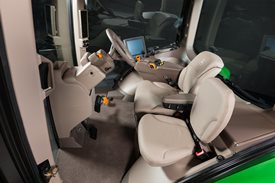 Ultimate Comfort and Convenience package
Ultimate Comfort and Convenience package
The Ultimate Comfort and Convenience package offers unsurpassed visibility, operator comfort, control placement, and ride and sound quality. Features in this package include:
Controls
- CommandARM™ console with hitch and hydraulic integrated controls
- Air conditioner and heater with automatic temperature controls
- Radio and volume controls
- Hitch control lever lock and selective control lever lock
- Tilt/telescoping steering wheel with position memory
- Auto trac resume button
- iTEC™ engagement buttons
Displays
- 21.3-cm (8.4-in.) 4200 or 26.4-cm (10.4-in.) 4600 Generation 4 CommandCenter™ Display
- Digital cornerpost display with:
- Fuel level gauge, including low fuel warning
- Temperature gauge
- Diesel exhaust fluid (DEF) gauge, including low DEF warning
- Engine rpm
- Transmission commanded gear or wheel speed
- Vehicle system functions, such as iTEC system, that are operating
- Monitor mounts on right-hand front post and rear cab post
Storage
- Storage compartment underneath the instructor seat
- Left-hand ceiling storage compartment
- Refrigerator located on the left side behind the instructor seat
- Beverage holders sized to accommodate various containers
Sound
- Passive noise reduction system
- Premium sound system, including touchscreen radio, smartphone interface, AM/FM/WX, aux and Bluetooth® with voice control, inputs, XM® ready, six speakers with one subwoofer, and business band ready
Outlets
- Three 12-V convenience outlet (cigarette lighter style)
- Six 12-V three-pin outlet with adapter (provides switched and unswitched power)
- Four charging USB ports
- 120-V AC power outlet
- One International Organization for Standardization (ISO) nine-pin connector
- Power strip with convenience plug adapter
- Service ADVISOR™ data port
Mirrors
- Inside-mounted rearview mirror
- Right and left outside mirrors (manually adjustable mirror head)
Windows
- Swing-out rear window that opens 30 degrees
- Laminated glass
- Two-speed and intermittent front, rear, and right-hand side wiper with washer
- Front, left and right-hand side, and rear pull-down sunshade
Lights
- Interior dome light in the ceiling
- Map lights
For additional attachments and mounting solutions, see Cab convenience or Cab mounting solutions.
Seat
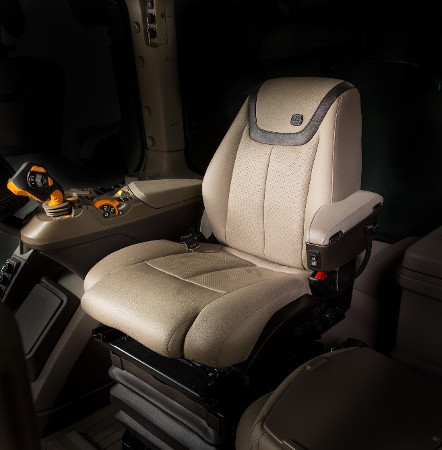 Leather seat
Leather seat
The seat improves ride quality and helps to reduce operator fatigue.
Features include:
- Leather
- Heat and ventilation to keep the operator at a comfortable temperature
- Adjustable bolsters
- Massage functionality
- Electronic controls to adjust to operator preference
- Pneumatic lumbar adjustment
- Seat height adjustments conveniently located below the left armrest
- Fore-aft adjustment is easy to reach, located below the left armrest
- Cushion length adjustment to get the perfect fit
- Swivel adjustment, located on the front of the seat, allows the seat to be swiveled 40 degrees to the right or 25 degrees to the left of the center position with a pivoting CommandARM console
- Seat can be configured with air seat suspension, ActiveSeat™ II suspension or air seat plus cab suspension
- Operator presence switch warns if the operator is out of the seat while operating key functions
- Seat belt retractor
- Centered cab seat provides excellent over-shoulder visibility
- Adjustable shock absorber permits ride adjustment from soft to firm to match the operator's desired comfort level
- Removable cushions allow for easy cleaning
- Folding instructional seat
Bluetooth is a trademark of Bluetooth SIG, Inc. XM is a trademark of Sirius XM Radio, Inc.
Get 360 degrees of coverage for maximum productivity with visibility packages
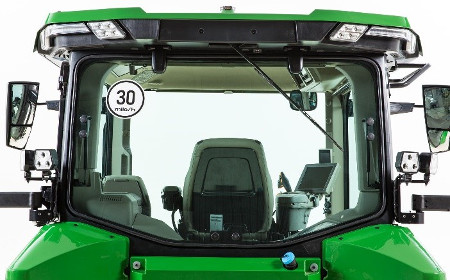 Ultimate Visibility package
Ultimate Visibility package
Visibility is one of the most important attributes of the cab. While lighting is a large portion of that, features like windshield wipers, mirrors, sunshades, and cameras are also important to overall visibility. For this reason, John Deere offers three visibility packages on 7 and 8 Family Tractors:
- Select
- Premium
- Ultimate
Lighting
The lighting configurations are available to match various applications and ensure maximum around-the-clock productivity.
Light housings are large, allowing for optimum total lumens and available light. The Select Visibility package uses 65-W halogen bulbs, whereas the Premium and Ultimate Visibility packages use light-emitting diode (LED) lights. The Premium and Ultimate Visibility packages replace Select Visibility package’s halogen lights with LED lights. The only lights that are not LED are the low-beam driving lights; they remain halogen. This allows each LED light to work at a lower temperature and no one light works harder than any other. The uniformity in LED coverage allows only one type of light output surrounding the tractor.
The lighting pattern in the Ultimate Visibility package provides industry-leading performance in nighttime visibility. LED lights provide maximum brightness and a true color output for excellent field definition that is easy on the operator's eyes.
The LED lights provide 40 percent greater coverage width and 10 percent more light coverage in the rear. LED lighting packages use 45 percent less amps than standard halogen lights and have an increased life expectancy over HID lights which leads to lower costs of ownership over the life of the tractor.
The low- and high-beam driving/work lights are adjustable. Please refer to the electrical section in the Operator’s Manual for complete details on adjusting lights.
NOTE: Lighting packages may vary depending on region.
Hydraulic pump options to meet varying flow requirements
 Hydraulic pump and filters
Hydraulic pump and filters
All 8 Family Tractors come standard with an 85-cc displacement integrated hydraulic pump. This pump provides 227.1 L/min (60 gpm) of hydraulic flow.
A dual-pump option, featuring 85-cc and 35-cc displacement hydraulic pumps, is available for all 8R and 8RX Tractors. The dual-pump system provides a hydraulic flow of 318 L/min (84 gpm), ideal for running at lower engine speeds.
Operating the tractor at reduced engine rpm contributes to a quieter cab, reduced fuel usage, and maintains the vacuum while turning and raising the planter on end rows. At 1500 engine rpm with a 318-L/min (84-gpm) system, there will be an available flow of 229 L/min (61 gpm). This is an improvement over an available 162-L/min (43-gpm) flow when operating with a 227-L/min (60-gpm) system at 1500 engine rpm.
SCV flow (approximate) |
||
Engine rpm |
Pump flow (85-cc pump) | High pump flow (85-cc pump + 35-cc optional pump) |
800 |
86 L/min (23 gpm) | 122 L/min (32 gpm) |
1500 |
162 L/min (43 gpm) | 229 L/min (61 gpm) |
1700 |
184 L/min (49 gpm) | 260 L/min (69 gpm) |
1900 |
206 L/min (54 gpm) | 290 L/min (77 gpm) |
2100 |
227 L/min (60 gpm) | 318 L/min (84 gpm) |
The maximum flow through one selective control valve (SCV) with a standard coupler is 132 L/min (35 gpm). A 19.1-mm (3/4-in.) high-flow coupler allows for a maximum flow rate out of one SCV of 153 L/min (40.5 gpm).
The hydraulic system is a closed-center, power-on-demand system using a load-sensing pressure-flow compensated axial piston pump with full-flow charge and flow prioritization for steering and brakes.
The pump outlet pressure available on demand can range from 3000 kPa (435 psi) for track models and 4000 kPa (580 psi) for wheel models at low standby to 20,400 kPa (2958 psi) at high standby.
John Deere Connected Support™ transforms the industry
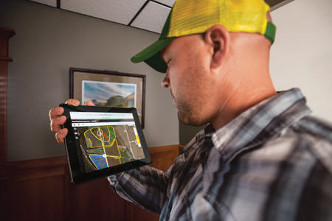 Maximizing uptime for John Deere customers through the use of connectivity and technology
Maximizing uptime for John Deere customers through the use of connectivity and technology
John Deere Connected Support is a proactive service approach that utilizes the telematics machine connection to leverage a suite of remote support tools available to improve service efficiency and reduce machine downtime on all 7, 8, and 9 Family Tractors.
- Proactive services that drive more uptime
- In-the-moment services to ensure quality job performance
- Leveraging technology to be more effective and efficient
You know that when you’re in the field the unexpected can happen. When it does, you need a quick resolution. That’s why John Deere equipment is prepared with technology that senses potential issues and can alert you promptly—in the cab or anywhere you are. Better yet, your dealer can receive alerts and connect to your equipment. You know your dealer is always ready to keep you farming – and farming better. Starting with model year 2020, your John Deere tractors will come with a 5-year JDLink™ subscription from the factory that makes this connection possible.
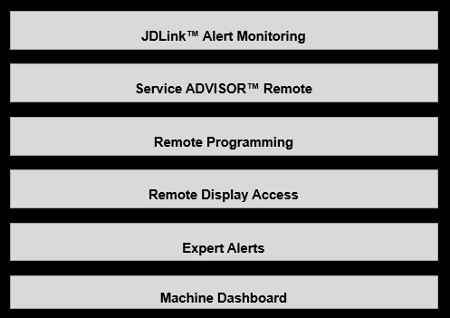 John Deere Connected Support tools
John Deere Connected Support tools
Stop fearing the unexpected and start planning for it with the following John Deere Connected Support tools.
Gain the advantages of a JDLink™ connected machine
 Monitor machines on the go
Monitor machines on the go
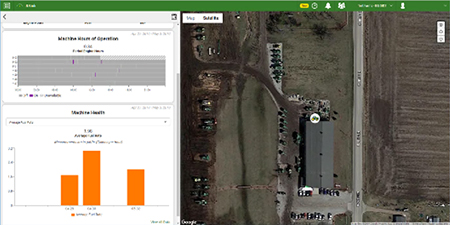 Connectivity provides data that drives better decisions
Connectivity provides data that drives better decisions
Customer needs and their success is John Deere’s focus. As functionality becomes more accepted and even expected, that functionality moves from being optional to being included with the machine. In model year 2019, AutoTrac™ guidance and documentation was included on machines equipped with a 4600 CommandCenter™ Display. Five years of JDLink is also included with the purchase of all model year 2020 machines equipped with a 4G LTE Modular Telematics Gateway (MTG). The functionality of JDLink on these machines includes everything that was previously included with JDLink Access + Remote Display Access (RDA) and JDLink Connect subscriptions. This added connectivity enables customers to more easily realize the value of a connected machine.
- Easily transfer data and collaborate with trusted advisors to plan your field work quickly. You or your employees can spend more time in the field working rather than sitting on a headland setting up the technology. With a connection between John Deere Operations Center and your machines, changes to field plans occur as needed. Those changes may include changes in varieties, application rates, or machines.
- Better enable data-driven decisions. By using the insights gathered from machines along with the tools in Operations Center (e.g., Field Analyzer, Field Analyzer Beta, and Machine Analyzer) you can understand how your fields are performing and what field plans had an impact. John Deere Operations Center gives you access to more than 100 connected software tools, so you have the ultimate choice of popular industry tools. And, if you don't want to analyze the data yourself, you can share the data with those that help you make decisions to provide the insights you need.
- Report work completed accurately and timely for compliance and billing purposes.
- Increase machine uptime with Connected Support. Your local John Deere dealer can provide remote monitoring services and diagnostics to help keep your machines up and running, reduce your maintenance expenses through early detection of problems, and provide over-the-air software updates for displays, receivers, and controllers.
- Get quick in-field support with RDA. You can monitor your machines from your office computer or a mobile device on the go.
- Remotely manage machines and employees to give you insights into how they are performing. If machines are being underutilized or field operations are not being properly conducted, you can put plans in place to improve productivity.
- Quickly make changes to improve your harvesting operations by remotely viewing and adjusting combine settings.
To use JDLink, the following is required:
- MTG
- An active JDLink subscription
- A John Deere Operations Center account to access machine and agronomic data
Take advantage of the Generation 4 CommandCenter™ display, designed for efficiency
The Generation 4 CommandCenter was designed to provide a consistent user experience by providing full-screen viewing of more run page modules, shortcut keys, and precision agriculture capabilities.
Expect easier set-up, along with increased operator confidence, thanks to a simple, customizable interface. The improved design of the Generation 4 CommandCenter also aids in an optimal operating experience and maximizes uptime.
In order to increase your efficiency, take advantage of the following features offered by the Generation 4 CommandCenter:
Layout manager
 Layout manager selection page
Layout manager selection page
 Layout manager module build
Layout manager module build
- Easily create page views that meet your needs and that are also equipped with default run pages.
- Users and access allow the owner or manager to lock out certain functions to prevent operators from accessing or changing settings with a defined four-digit code.
- Gather on-screen help by selecting the help icon on the shortcut bar on the bottom of every page.
Machine monitor
 Machine monitor page
Machine monitor page
- The Machine Monitor application provides you instantaneous readings about the status or condition of your machine.
- This application shows parameters such as engine speed, coolant temperature, and ground speed.
Work monitor
 Work monitor page
Work monitor page
- The Work Monitor application displays performance information about the task being performed by the machine.
- You are shown averages, totals, and productivity of the machine, such as area worked, average working speed, and fuel usage.
- Work setup places the settings needed to properly setup features such as AutoTrac, Documentation, and Section Control in a single location. Settings include:
- Client, farm, and field
- Crop type
- Machine and implement dimensions
- Variety/hybrid and planting/seeding rates
- Variable rate prescriptions
- Product and application rates
- Application rates through the implement screens
Video capability
- Machines equipped with a 4200 CommandCenter are equipped with one video input, and the 4600 CommandCenter has four video inputs.
- You have the ability to set a variety of triggers. With each trigger, the image will then appear on the display.
Flags
 Create flags to mark items in the field
Create flags to mark items in the field
- Mark areas in the field that need special attention such as rocks, tile lines, or weed pressure.
- Flags previously recorded on the Gen 4 or GreenStar™ 3 2630 Display can be transferred between monitors.
- Flags previously recorded on the Gen 4 or GreenStar™ 3 2630 Display can be transferred between monitors.
Field boundaries
 Boundary creation from coverage
Boundary creation from coverage
 Headland creation
Headland creation
- Manually drive field boundaries with the Generation 4 CommandCenter or import existing boundary information from the GreenStar 3 2630 Display or John Deere Operations Center. Gen 4 documentation data can be used to create boundaries from coverage within the John Deere Operations Center.
Dual-display mode
 Dual display
Dual display
- Generation 4 CommandCenter may be configured to run with the following John Deere displays connected at the cornerpost of a John Deere tractor:
- GreenStar 2 1800 Display
- GreenStar 2 2600 Display
- GreenStar 3 2630 Display
- 4640 Universal Display
- 4240 Universal Display
NOTE: Vehicle applications will always be located on the Gen 4 CommandCenter.
Automatic base station switching
 Setup base stations in Fields and Boundaries applications
Setup base stations in Fields and Boundaries applications
- Customers using John Deere RTK Radio 450 or 900 can link a base station to a desired client,/ farm,/ or field. This allows automatic switching to the associated base station when changing fields. The ability to import base station assignments into Operations Center and send back to machines will be available at a later date.
Video looping supported with Gen 4 4600 CommandCenter Display and 4640 Universal Display
 Scan through videos with video looping
Scan through videos with video looping
- This feature enables users to scan or loop through all of the available video feeds for a specified duration. The default scan time is set to 7 seconds per image. The scan time is customizable per image allowing for consistent visibility to all video feeds.
Simple turnkey experience with the StarFire™ 6000 Integrated Receiver
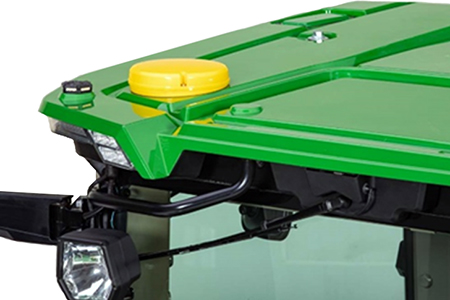 StarFire 6000 Integrated Receiver
StarFire 6000 Integrated Receiver
The John Deere StarFire™ 6000 Integrated Receiver is the new standard in John Deere Precision Ag technology. The integrated design further enhances the value that you have come to expect from StarFire products.
The StarFire 6000 Integrated Receiver eliminates all setup, installation, and calibrations. There is no need to verify machine and receiver measurements, as this has been done precisely for you at the factory. You will spend 60 minutes less per receiver move each season, which gives you more time to focus on other parts of your operation.
With updated Ethernet connectivity, software updates are easier and faster. StarFire 6000 Integrated Receiver maintains the speed to update software in under 4 minutes while remaining in the cab. Over-the-air updates are 85 percent faster with the StarFire 6000 Integrated Receiver because of Ethernet connectivity.
Features
Experience the ultimate in comfort with the Ultimate Comfort and Convenience package
 Ultimate Comfort and Convenience package
Ultimate Comfort and Convenience package
The Ultimate Comfort and Convenience package offers unsurpassed visibility, operator comfort, control placement, and ride and sound quality. Features in this package include:
Controls
- CommandARM™ console with hitch and hydraulic integrated controls
- Air conditioner and heater with automatic temperature controls
- Radio and volume controls
- Hitch control lever lock and selective control lever lock
- Tilt/telescoping steering wheel with position memory
- Auto trac resume button
- iTEC™ engagement buttons
Displays
- 21.3-cm (8.4-in.) 4200 or 26.4-cm (10.4-in.) 4600 Generation 4 CommandCenter™ Display
- Digital cornerpost display with:
- Fuel level gauge, including low fuel warning
- Temperature gauge
- Diesel exhaust fluid (DEF) gauge, including low DEF warning
- Engine rpm
- Transmission commanded gear or wheel speed
- Vehicle system functions, such as iTEC system, that are operating
- Monitor mounts on right-hand front post and rear cab post
Storage
- Storage compartment underneath the instructor seat
- Left-hand ceiling storage compartment
- Refrigerator located on the left side behind the instructor seat
- Beverage holders sized to accommodate various containers
Sound
- Passive noise reduction system
- Premium sound system, including touchscreen radio, smartphone interface, AM/FM/WX, aux and Bluetooth® with voice control, inputs, XM® ready, six speakers with one subwoofer, and business band ready
Outlets
- Three 12-V convenience outlet (cigarette lighter style)
- Six 12-V three-pin outlet with adapter (provides switched and unswitched power)
- Four charging USB ports
- 120-V AC power outlet
- One International Organization for Standardization (ISO) nine-pin connector
- Power strip with convenience plug adapter
- Service ADVISOR™ data port
Mirrors
- Inside-mounted rearview mirror
- Right and left outside mirrors (manually adjustable mirror head)
Windows
- Swing-out rear window that opens 30 degrees
- Laminated glass
- Two-speed and intermittent front, rear, and right-hand side wiper with washer
- Front, left and right-hand side, and rear pull-down sunshade
Lights
- Interior dome light in the ceiling
- Map lights
For additional attachments and mounting solutions, see Cab convenience or Cab mounting solutions.
Seat
 Leather seat
Leather seat
The seat improves ride quality and helps to reduce operator fatigue.
Features include:
- Leather
- Heat and ventilation to keep the operator at a comfortable temperature
- Adjustable bolsters
- Massage functionality
- Electronic controls to adjust to operator preference
- Pneumatic lumbar adjustment
- Seat height adjustments conveniently located below the left armrest
- Fore-aft adjustment is easy to reach, located below the left armrest
- Cushion length adjustment to get the perfect fit
- Swivel adjustment, located on the front of the seat, allows the seat to be swiveled 40 degrees to the right or 25 degrees to the left of the center position with a pivoting CommandARM console
- Seat can be configured with air seat suspension, ActiveSeat™ II suspension or air seat plus cab suspension
- Operator presence switch warns if the operator is out of the seat while operating key functions
- Seat belt retractor
- Centered cab seat provides excellent over-shoulder visibility
- Adjustable shock absorber permits ride adjustment from soft to firm to match the operator's desired comfort level
- Removable cushions allow for easy cleaning
- Folding instructional seat
Bluetooth is a trademark of Bluetooth SIG, Inc. XM is a trademark of Sirius XM Radio, Inc.
Get 360 degrees of coverage for maximum productivity with visibility packages
 Ultimate Visibility package
Ultimate Visibility package
Visibility is one of the most important attributes of the cab. While lighting is a large portion of that, features like windshield wipers, mirrors, sunshades, and cameras are also important to overall visibility. For this reason, John Deere offers three visibility packages on 7 and 8 Family Tractors:
- Select
- Premium
- Ultimate
Lighting
The lighting configurations are available to match various applications and ensure maximum around-the-clock productivity.
Light housings are large, allowing for optimum total lumens and available light. The Select Visibility package uses 65-W halogen bulbs, whereas the Premium and Ultimate Visibility packages use light-emitting diode (LED) lights. The Premium and Ultimate Visibility packages replace Select Visibility package’s halogen lights with LED lights. The only lights that are not LED are the low-beam driving lights; they remain halogen. This allows each LED light to work at a lower temperature and no one light works harder than any other. The uniformity in LED coverage allows only one type of light output surrounding the tractor.
The lighting pattern in the Ultimate Visibility package provides industry-leading performance in nighttime visibility. LED lights provide maximum brightness and a true color output for excellent field definition that is easy on the operator's eyes.
The LED lights provide 40 percent greater coverage width and 10 percent more light coverage in the rear. LED lighting packages use 45 percent less amps than standard halogen lights and have an increased life expectancy over HID lights which leads to lower costs of ownership over the life of the tractor.
The low- and high-beam driving/work lights are adjustable. Please refer to the electrical section in the Operator’s Manual for complete details on adjusting lights.
NOTE: Lighting packages may vary depending on region.
Hydraulic pump options to meet varying flow requirements
 Hydraulic pump and filters
Hydraulic pump and filters
All 8 Family Tractors come standard with an 85-cc displacement integrated hydraulic pump. This pump provides 227.1 L/min (60 gpm) of hydraulic flow.
A dual-pump option, featuring 85-cc and 35-cc displacement hydraulic pumps, is available for all 8R and 8RX Tractors. The dual-pump system provides a hydraulic flow of 318 L/min (84 gpm), ideal for running at lower engine speeds.
Operating the tractor at reduced engine rpm contributes to a quieter cab, reduced fuel usage, and maintains the vacuum while turning and raising the planter on end rows. At 1500 engine rpm with a 318-L/min (84-gpm) system, there will be an available flow of 229 L/min (61 gpm). This is an improvement over an available 162-L/min (43-gpm) flow when operating with a 227-L/min (60-gpm) system at 1500 engine rpm.
SCV flow (approximate) |
||
Engine rpm |
Pump flow (85-cc pump) | High pump flow (85-cc pump + 35-cc optional pump) |
800 |
86 L/min (23 gpm) | 122 L/min (32 gpm) |
1500 |
162 L/min (43 gpm) | 229 L/min (61 gpm) |
1700 |
184 L/min (49 gpm) | 260 L/min (69 gpm) |
1900 |
206 L/min (54 gpm) | 290 L/min (77 gpm) |
2100 |
227 L/min (60 gpm) | 318 L/min (84 gpm) |
The maximum flow through one selective control valve (SCV) with a standard coupler is 132 L/min (35 gpm). A 19.1-mm (3/4-in.) high-flow coupler allows for a maximum flow rate out of one SCV of 153 L/min (40.5 gpm).
The hydraulic system is a closed-center, power-on-demand system using a load-sensing pressure-flow compensated axial piston pump with full-flow charge and flow prioritization for steering and brakes.
The pump outlet pressure available on demand can range from 3000 kPa (435 psi) for track models and 4000 kPa (580 psi) for wheel models at low standby to 20,400 kPa (2958 psi) at high standby.
John Deere Connected Support™ transforms the industry
 Maximizing uptime for John Deere customers through the use of connectivity and technology
Maximizing uptime for John Deere customers through the use of connectivity and technology
John Deere Connected Support is a proactive service approach that utilizes the telematics machine connection to leverage a suite of remote support tools available to improve service efficiency and reduce machine downtime on all 7, 8, and 9 Family Tractors.
- Proactive services that drive more uptime
- In-the-moment services to ensure quality job performance
- Leveraging technology to be more effective and efficient
You know that when you’re in the field the unexpected can happen. When it does, you need a quick resolution. That’s why John Deere equipment is prepared with technology that senses potential issues and can alert you promptly—in the cab or anywhere you are. Better yet, your dealer can receive alerts and connect to your equipment. You know your dealer is always ready to keep you farming – and farming better. Starting with model year 2020, your John Deere tractors will come with a 5-year JDLink™ subscription from the factory that makes this connection possible.
 John Deere Connected Support tools
John Deere Connected Support tools
Stop fearing the unexpected and start planning for it with the following John Deere Connected Support tools.
Gain the advantages of a JDLink™ connected machine
 Monitor machines on the go
Monitor machines on the go
 Connectivity provides data that drives better decisions
Connectivity provides data that drives better decisions
Customer needs and their success is John Deere’s focus. As functionality becomes more accepted and even expected, that functionality moves from being optional to being included with the machine. In model year 2019, AutoTrac™ guidance and documentation was included on machines equipped with a 4600 CommandCenter™ Display. Five years of JDLink is also included with the purchase of all model year 2020 machines equipped with a 4G LTE Modular Telematics Gateway (MTG). The functionality of JDLink on these machines includes everything that was previously included with JDLink Access + Remote Display Access (RDA) and JDLink Connect subscriptions. This added connectivity enables customers to more easily realize the value of a connected machine.
- Easily transfer data and collaborate with trusted advisors to plan your field work quickly. You or your employees can spend more time in the field working rather than sitting on a headland setting up the technology. With a connection between John Deere Operations Center and your machines, changes to field plans occur as needed. Those changes may include changes in varieties, application rates, or machines.
- Better enable data-driven decisions. By using the insights gathered from machines along with the tools in Operations Center (e.g., Field Analyzer, Field Analyzer Beta, and Machine Analyzer) you can understand how your fields are performing and what field plans had an impact. John Deere Operations Center gives you access to more than 100 connected software tools, so you have the ultimate choice of popular industry tools. And, if you don't want to analyze the data yourself, you can share the data with those that help you make decisions to provide the insights you need.
- Report work completed accurately and timely for compliance and billing purposes.
- Increase machine uptime with Connected Support. Your local John Deere dealer can provide remote monitoring services and diagnostics to help keep your machines up and running, reduce your maintenance expenses through early detection of problems, and provide over-the-air software updates for displays, receivers, and controllers.
- Get quick in-field support with RDA. You can monitor your machines from your office computer or a mobile device on the go.
- Remotely manage machines and employees to give you insights into how they are performing. If machines are being underutilized or field operations are not being properly conducted, you can put plans in place to improve productivity.
- Quickly make changes to improve your harvesting operations by remotely viewing and adjusting combine settings.
To use JDLink, the following is required:
- MTG
- An active JDLink subscription
- A John Deere Operations Center account to access machine and agronomic data
Take advantage of the Generation 4 CommandCenter™ display, designed for efficiency
The Generation 4 CommandCenter was designed to provide a consistent user experience by providing full-screen viewing of more run page modules, shortcut keys, and precision agriculture capabilities.
Expect easier set-up, along with increased operator confidence, thanks to a simple, customizable interface. The improved design of the Generation 4 CommandCenter also aids in an optimal operating experience and maximizes uptime.
In order to increase your efficiency, take advantage of the following features offered by the Generation 4 CommandCenter:
Layout manager
 Layout manager selection page
Layout manager selection page
 Layout manager module build
Layout manager module build
- Easily create page views that meet your needs and that are also equipped with default run pages.
- Users and access allow the owner or manager to lock out certain functions to prevent operators from accessing or changing settings with a defined four-digit code.
- Gather on-screen help by selecting the help icon on the shortcut bar on the bottom of every page.
Machine monitor
 Machine monitor page
Machine monitor page
- The Machine Monitor application provides you instantaneous readings about the status or condition of your machine.
- This application shows parameters such as engine speed, coolant temperature, and ground speed.
Work monitor
 Work monitor page
Work monitor page
- The Work Monitor application displays performance information about the task being performed by the machine.
- You are shown averages, totals, and productivity of the machine, such as area worked, average working speed, and fuel usage.
- Work setup places the settings needed to properly setup features such as AutoTrac, Documentation, and Section Control in a single location. Settings include:
- Client, farm, and field
- Crop type
- Machine and implement dimensions
- Variety/hybrid and planting/seeding rates
- Variable rate prescriptions
- Product and application rates
- Application rates through the implement screens
Video capability
- Machines equipped with a 4200 CommandCenter are equipped with one video input, and the 4600 CommandCenter has four video inputs.
- You have the ability to set a variety of triggers. With each trigger, the image will then appear on the display.
Flags
 Create flags to mark items in the field
Create flags to mark items in the field
- Mark areas in the field that need special attention such as rocks, tile lines, or weed pressure.
- Flags previously recorded on the Gen 4 or GreenStar™ 3 2630 Display can be transferred between monitors.
- Flags previously recorded on the Gen 4 or GreenStar™ 3 2630 Display can be transferred between monitors.
Field boundaries
 Boundary creation from coverage
Boundary creation from coverage
 Headland creation
Headland creation
- Manually drive field boundaries with the Generation 4 CommandCenter or import existing boundary information from the GreenStar 3 2630 Display or John Deere Operations Center. Gen 4 documentation data can be used to create boundaries from coverage within the John Deere Operations Center.
Dual-display mode
 Dual display
Dual display
- Generation 4 CommandCenter may be configured to run with the following John Deere displays connected at the cornerpost of a John Deere tractor:
- GreenStar 2 1800 Display
- GreenStar 2 2600 Display
- GreenStar 3 2630 Display
- 4640 Universal Display
- 4240 Universal Display
NOTE: Vehicle applications will always be located on the Gen 4 CommandCenter.
Automatic base station switching
 Setup base stations in Fields and Boundaries applications
Setup base stations in Fields and Boundaries applications
- Customers using John Deere RTK Radio 450 or 900 can link a base station to a desired client,/ farm,/ or field. This allows automatic switching to the associated base station when changing fields. The ability to import base station assignments into Operations Center and send back to machines will be available at a later date.
Video looping supported with Gen 4 4600 CommandCenter Display and 4640 Universal Display
 Scan through videos with video looping
Scan through videos with video looping
- This feature enables users to scan or loop through all of the available video feeds for a specified duration. The default scan time is set to 7 seconds per image. The scan time is customizable per image allowing for consistent visibility to all video feeds.
Simple turnkey experience with the StarFire™ 6000 Integrated Receiver
 StarFire 6000 Integrated Receiver
StarFire 6000 Integrated Receiver
The John Deere StarFire™ 6000 Integrated Receiver is the new standard in John Deere Precision Ag technology. The integrated design further enhances the value that you have come to expect from StarFire products.
The StarFire 6000 Integrated Receiver eliminates all setup, installation, and calibrations. There is no need to verify machine and receiver measurements, as this has been done precisely for you at the factory. You will spend 60 minutes less per receiver move each season, which gives you more time to focus on other parts of your operation.
With updated Ethernet connectivity, software updates are easier and faster. StarFire 6000 Integrated Receiver maintains the speed to update software in under 4 minutes while remaining in the cab. Over-the-air updates are 85 percent faster with the StarFire 6000 Integrated Receiver because of Ethernet connectivity.
Features
Experience the ultimate in comfort with the Ultimate Comfort and Convenience package
 Ultimate Comfort and Convenience package
Ultimate Comfort and Convenience package
The Ultimate Comfort and Convenience package offers unsurpassed visibility, operator comfort, control placement, and ride and sound quality. Features in this package include:
Controls
- CommandARM™ console with hitch and hydraulic integrated controls
- Air conditioner and heater with automatic temperature controls
- Radio and volume controls
- Hitch control lever lock and selective control lever lock
- Tilt/telescoping steering wheel with position memory
- Auto trac resume button
- iTEC™ engagement buttons
Displays
- 21.3-cm (8.4-in.) 4200 or 26.4-cm (10.4-in.) 4600 Generation 4 CommandCenter™ Display
- Digital cornerpost display with:
- Fuel level gauge, including low fuel warning
- Temperature gauge
- Diesel exhaust fluid (DEF) gauge, including low DEF warning
- Engine rpm
- Transmission commanded gear or wheel speed
- Vehicle system functions, such as iTEC system, that are operating
- Monitor mounts on right-hand front post and rear cab post
Storage
- Storage compartment underneath the instructor seat
- Left-hand ceiling storage compartment
- Refrigerator located on the left side behind the instructor seat
- Beverage holders sized to accommodate various containers
Sound
- Passive noise reduction system
- Premium sound system, including touchscreen radio, smartphone interface, AM/FM/WX, aux and Bluetooth® with voice control, inputs, XM® ready, six speakers with one subwoofer, and business band ready
Outlets
- Three 12-V convenience outlet (cigarette lighter style)
- Six 12-V three-pin outlet with adapter (provides switched and unswitched power)
- Four charging USB ports
- 120-V AC power outlet
- One International Organization for Standardization (ISO) nine-pin connector
- Power strip with convenience plug adapter
- Service ADVISOR™ data port
Mirrors
- Inside-mounted rearview mirror
- Right and left outside mirrors (manually adjustable mirror head)
Windows
- Swing-out rear window that opens 30 degrees
- Laminated glass
- Two-speed and intermittent front, rear, and right-hand side wiper with washer
- Front, left and right-hand side, and rear pull-down sunshade
Lights
- Interior dome light in the ceiling
- Map lights
For additional attachments and mounting solutions, see Cab convenience or Cab mounting solutions.
Seat
 Leather seat
Leather seat
The seat improves ride quality and helps to reduce operator fatigue.
Features include:
- Leather
- Heat and ventilation to keep the operator at a comfortable temperature
- Adjustable bolsters
- Massage functionality
- Electronic controls to adjust to operator preference
- Pneumatic lumbar adjustment
- Seat height adjustments conveniently located below the left armrest
- Fore-aft adjustment is easy to reach, located below the left armrest
- Cushion length adjustment to get the perfect fit
- Swivel adjustment, located on the front of the seat, allows the seat to be swiveled 40 degrees to the right or 25 degrees to the left of the center position with a pivoting CommandARM console
- Seat can be configured with air seat suspension, ActiveSeat™ II suspension or air seat plus cab suspension
- Operator presence switch warns if the operator is out of the seat while operating key functions
- Seat belt retractor
- Centered cab seat provides excellent over-shoulder visibility
- Adjustable shock absorber permits ride adjustment from soft to firm to match the operator's desired comfort level
- Removable cushions allow for easy cleaning
- Folding instructional seat
Bluetooth is a trademark of Bluetooth SIG, Inc. XM is a trademark of Sirius XM Radio, Inc.
Get 360 degrees of coverage for maximum productivity with visibility packages
 Ultimate Visibility package
Ultimate Visibility package
Visibility is one of the most important attributes of the cab. While lighting is a large portion of that, features like windshield wipers, mirrors, sunshades, and cameras are also important to overall visibility. For this reason, John Deere offers three visibility packages on 7 and 8 Family Tractors:
- Select
- Premium
- Ultimate
Lighting
The lighting configurations are available to match various applications and ensure maximum around-the-clock productivity.
Light housings are large, allowing for optimum total lumens and available light. The Select Visibility package uses 65-W halogen bulbs, whereas the Premium and Ultimate Visibility packages use light-emitting diode (LED) lights. The Premium and Ultimate Visibility packages replace Select Visibility package’s halogen lights with LED lights. The only lights that are not LED are the low-beam driving lights; they remain halogen. This allows each LED light to work at a lower temperature and no one light works harder than any other. The uniformity in LED coverage allows only one type of light output surrounding the tractor.
The lighting pattern in the Ultimate Visibility package provides industry-leading performance in nighttime visibility. LED lights provide maximum brightness and a true color output for excellent field definition that is easy on the operator's eyes.
The LED lights provide 40 percent greater coverage width and 10 percent more light coverage in the rear. LED lighting packages use 45 percent less amps than standard halogen lights and have an increased life expectancy over HID lights which leads to lower costs of ownership over the life of the tractor.
The low- and high-beam driving/work lights are adjustable. Please refer to the electrical section in the Operator’s Manual for complete details on adjusting lights.
NOTE: Lighting packages may vary depending on region.
ActiveSeat™ II seat provides a smoother ride
 ActiveSeat II
ActiveSeat II
The John Deere Active Seat II utilizes an electrical control system to control the vertical seat top movement. The "active" control system minimizes vertical seat top acceleration by sensing vertical tractor inputs and actively positioning the seat top to cancel those inputs. This results in a significantly smoother ride for the operator.
The John Deere ActiveSeat II has many of the same features of the air suspension seat with the addition of a ride firmness switch. The ride firmness switch is located on the left-hand armrest and replaces the suspension shock-dampening seat attenuation lever on the front right-hand side of the seat controls.
The ride firmness switch has three positions: plus, minus, and mid position. The three positions provide three different levels of seat performance:
- The plus position provides the greatest degree of ride firmness. This position allows more of the tractor's inputs to be felt by the operator (slightly rougher ride).
- The minus position provides the least degree of ride firmness, allowing minimal tractor inputs to reach the operator, resulting in maximum seat performance.
- The mid position allows a balance between the plus (+) and minus (-) settings.
 ActiveSeat II left armrest controls
ActiveSeat II left armrest controls
The ActiveSeat II is also available as a heated and ventilated leather seat for increased comfort and easier cleaning. This is only available with the Ultimate Comfort and Convenience package. For tractor applications where operating speed is not limited by the implement, the ActiveSeat II can allow for faster field speeds and increased overall comfort and productivity.
The leather seat includes massaging capability to alleviate operator fatigue.
Right-hand seat swivel has been improved above current 8R Tractors to 25 degrees (versus 8 degrees) to the left and 40 degrees to the right in the Premium and Ultimate Comfort and Convenience packages.
NOTE: The John Deere ActiveSeat II is not available on track tractors.
Unsurpassed gains in productivity with Independent-Link Suspension (ILS™)
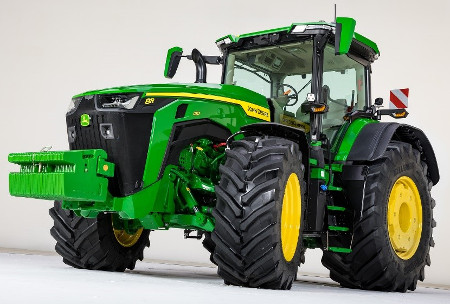 8R Tractor equipped with ILS
8R Tractor equipped with ILS
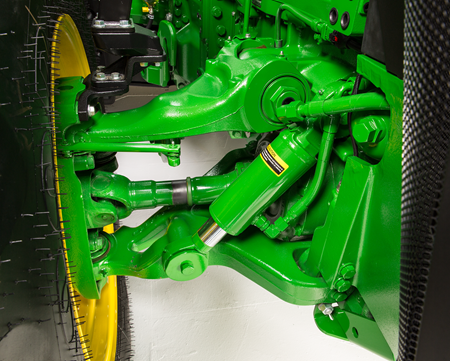 Close-up view of ILS design
Close-up view of ILS design
The John Deere ILS utilizes industry-leading technology to supply unsurpassed gains to end-user productivity. This innovative design incorporates proven suspension design with mechanical front-wheel drive (MFWD) axle components that use state-of-the-art technology specifically for heavy equipment usage. Operators do not have to worry about turning ILS on/off since the John Deere advanced electronic management system knows when to disengage ILS automatically.
The ILS system gets more power to the ground because the front tires maintain ground contact pressure. This improves field and transport ride plus increases ballasting flexibility and drastically decreases the tendency to power hop.
Hydraulic pump options to meet varying flow requirements
 Hydraulic pump and filters
Hydraulic pump and filters
All 8 Family Tractors come standard with an 85-cc displacement integrated hydraulic pump. This pump provides 227.1 L/min (60 gpm) of hydraulic flow.
A dual-pump option, featuring 85-cc and 35-cc displacement hydraulic pumps, is available for all 8R and 8RX Tractors. The dual-pump system provides a hydraulic flow of 318 L/min (84 gpm), ideal for running at lower engine speeds.
Operating the tractor at reduced engine rpm contributes to a quieter cab, reduced fuel usage, and maintains the vacuum while turning and raising the planter on end rows. At 1500 engine rpm with a 318-L/min (84-gpm) system, there will be an available flow of 229 L/min (61 gpm). This is an improvement over an available 162-L/min (43-gpm) flow when operating with a 227-L/min (60-gpm) system at 1500 engine rpm.
SCV flow (approximate) |
||
Engine rpm |
Pump flow (85-cc pump) | High pump flow (85-cc pump + 35-cc optional pump) |
800 |
86 L/min (23 gpm) | 122 L/min (32 gpm) |
1500 |
162 L/min (43 gpm) | 229 L/min (61 gpm) |
1700 |
184 L/min (49 gpm) | 260 L/min (69 gpm) |
1900 |
206 L/min (54 gpm) | 290 L/min (77 gpm) |
2100 |
227 L/min (60 gpm) | 318 L/min (84 gpm) |
The maximum flow through one selective control valve (SCV) with a standard coupler is 132 L/min (35 gpm). A 19.1-mm (3/4-in.) high-flow coupler allows for a maximum flow rate out of one SCV of 153 L/min (40.5 gpm).
The hydraulic system is a closed-center, power-on-demand system using a load-sensing pressure-flow compensated axial piston pump with full-flow charge and flow prioritization for steering and brakes.
The pump outlet pressure available on demand can range from 3000 kPa (435 psi) for track models and 4000 kPa (580 psi) for wheel models at low standby to 20,400 kPa (2958 psi) at high standby.
John Deere Connected Support™ transforms the industry
 Maximizing uptime for John Deere customers through the use of connectivity and technology
Maximizing uptime for John Deere customers through the use of connectivity and technology
John Deere Connected Support is a proactive service approach that utilizes the telematics machine connection to leverage a suite of remote support tools available to improve service efficiency and reduce machine downtime on all 7, 8, and 9 Family Tractors.
- Proactive services that drive more uptime
- In-the-moment services to ensure quality job performance
- Leveraging technology to be more effective and efficient
You know that when you’re in the field the unexpected can happen. When it does, you need a quick resolution. That’s why John Deere equipment is prepared with technology that senses potential issues and can alert you promptly—in the cab or anywhere you are. Better yet, your dealer can receive alerts and connect to your equipment. You know your dealer is always ready to keep you farming – and farming better. Starting with model year 2020, your John Deere tractors will come with a 5-year JDLink™ subscription from the factory that makes this connection possible.
 John Deere Connected Support tools
John Deere Connected Support tools
Stop fearing the unexpected and start planning for it with the following John Deere Connected Support tools.
Gain the advantages of a JDLink™ connected machine
 Monitor machines on the go
Monitor machines on the go
 Connectivity provides data that drives better decisions
Connectivity provides data that drives better decisions
Customer needs and their success is John Deere’s focus. As functionality becomes more accepted and even expected, that functionality moves from being optional to being included with the machine. In model year 2019, AutoTrac™ guidance and documentation was included on machines equipped with a 4600 CommandCenter™ Display. Five years of JDLink is also included with the purchase of all model year 2020 machines equipped with a 4G LTE Modular Telematics Gateway (MTG). The functionality of JDLink on these machines includes everything that was previously included with JDLink Access + Remote Display Access (RDA) and JDLink Connect subscriptions. This added connectivity enables customers to more easily realize the value of a connected machine.
- Easily transfer data and collaborate with trusted advisors to plan your field work quickly. You or your employees can spend more time in the field working rather than sitting on a headland setting up the technology. With a connection between John Deere Operations Center and your machines, changes to field plans occur as needed. Those changes may include changes in varieties, application rates, or machines.
- Better enable data-driven decisions. By using the insights gathered from machines along with the tools in Operations Center (e.g., Field Analyzer, Field Analyzer Beta, and Machine Analyzer) you can understand how your fields are performing and what field plans had an impact. John Deere Operations Center gives you access to more than 100 connected software tools, so you have the ultimate choice of popular industry tools. And, if you don't want to analyze the data yourself, you can share the data with those that help you make decisions to provide the insights you need.
- Report work completed accurately and timely for compliance and billing purposes.
- Increase machine uptime with Connected Support. Your local John Deere dealer can provide remote monitoring services and diagnostics to help keep your machines up and running, reduce your maintenance expenses through early detection of problems, and provide over-the-air software updates for displays, receivers, and controllers.
- Get quick in-field support with RDA. You can monitor your machines from your office computer or a mobile device on the go.
- Remotely manage machines and employees to give you insights into how they are performing. If machines are being underutilized or field operations are not being properly conducted, you can put plans in place to improve productivity.
- Quickly make changes to improve your harvesting operations by remotely viewing and adjusting combine settings.
To use JDLink, the following is required:
- MTG
- An active JDLink subscription
- A John Deere Operations Center account to access machine and agronomic data
Take advantage of the Generation 4 CommandCenter™ display, designed for efficiency
The Generation 4 CommandCenter was designed to provide a consistent user experience by providing full-screen viewing of more run page modules, shortcut keys, and precision agriculture capabilities.
Expect easier set-up, along with increased operator confidence, thanks to a simple, customizable interface. The improved design of the Generation 4 CommandCenter also aids in an optimal operating experience and maximizes uptime.
In order to increase your efficiency, take advantage of the following features offered by the Generation 4 CommandCenter:
Layout manager
 Layout manager selection page
Layout manager selection page
 Layout manager module build
Layout manager module build
- Easily create page views that meet your needs and that are also equipped with default run pages.
- Users and access allow the owner or manager to lock out certain functions to prevent operators from accessing or changing settings with a defined four-digit code.
- Gather on-screen help by selecting the help icon on the shortcut bar on the bottom of every page.
Machine monitor
 Machine monitor page
Machine monitor page
- The Machine Monitor application provides you instantaneous readings about the status or condition of your machine.
- This application shows parameters such as engine speed, coolant temperature, and ground speed.
Work monitor
 Work monitor page
Work monitor page
- The Work Monitor application displays performance information about the task being performed by the machine.
- You are shown averages, totals, and productivity of the machine, such as area worked, average working speed, and fuel usage.
- Work setup places the settings needed to properly setup features such as AutoTrac, Documentation, and Section Control in a single location. Settings include:
- Client, farm, and field
- Crop type
- Machine and implement dimensions
- Variety/hybrid and planting/seeding rates
- Variable rate prescriptions
- Product and application rates
- Application rates through the implement screens
Video capability
- Machines equipped with a 4200 CommandCenter are equipped with one video input, and the 4600 CommandCenter has four video inputs.
- You have the ability to set a variety of triggers. With each trigger, the image will then appear on the display.
Flags
 Create flags to mark items in the field
Create flags to mark items in the field
- Mark areas in the field that need special attention such as rocks, tile lines, or weed pressure.
- Flags previously recorded on the Gen 4 or GreenStar™ 3 2630 Display can be transferred between monitors.
- Flags previously recorded on the Gen 4 or GreenStar™ 3 2630 Display can be transferred between monitors.
Field boundaries
 Boundary creation from coverage
Boundary creation from coverage
 Headland creation
Headland creation
- Manually drive field boundaries with the Generation 4 CommandCenter or import existing boundary information from the GreenStar 3 2630 Display or John Deere Operations Center. Gen 4 documentation data can be used to create boundaries from coverage within the John Deere Operations Center.
Dual-display mode
 Dual display
Dual display
- Generation 4 CommandCenter may be configured to run with the following John Deere displays connected at the cornerpost of a John Deere tractor:
- GreenStar 2 1800 Display
- GreenStar 2 2600 Display
- GreenStar 3 2630 Display
- 4640 Universal Display
- 4240 Universal Display
NOTE: Vehicle applications will always be located on the Gen 4 CommandCenter.
Automatic base station switching
 Setup base stations in Fields and Boundaries applications
Setup base stations in Fields and Boundaries applications
- Customers using John Deere RTK Radio 450 or 900 can link a base station to a desired client,/ farm,/ or field. This allows automatic switching to the associated base station when changing fields. The ability to import base station assignments into Operations Center and send back to machines will be available at a later date.
Video looping supported with Gen 4 4600 CommandCenter Display and 4640 Universal Display
 Scan through videos with video looping
Scan through videos with video looping
- This feature enables users to scan or loop through all of the available video feeds for a specified duration. The default scan time is set to 7 seconds per image. The scan time is customizable per image allowing for consistent visibility to all video feeds.
Simple turnkey experience with the StarFire™ 6000 Integrated Receiver
 StarFire 6000 Integrated Receiver
StarFire 6000 Integrated Receiver
The John Deere StarFire™ 6000 Integrated Receiver is the new standard in John Deere Precision Ag technology. The integrated design further enhances the value that you have come to expect from StarFire products.
The StarFire 6000 Integrated Receiver eliminates all setup, installation, and calibrations. There is no need to verify machine and receiver measurements, as this has been done precisely for you at the factory. You will spend 60 minutes less per receiver move each season, which gives you more time to focus on other parts of your operation.
With updated Ethernet connectivity, software updates are easier and faster. StarFire 6000 Integrated Receiver maintains the speed to update software in under 4 minutes while remaining in the cab. Over-the-air updates are 85 percent faster with the StarFire 6000 Integrated Receiver because of Ethernet connectivity.
Features
Experience the ultimate in comfort with the Ultimate Comfort and Convenience package
 Ultimate Comfort and Convenience package
Ultimate Comfort and Convenience package
The Ultimate Comfort and Convenience package offers unsurpassed visibility, operator comfort, control placement, and ride and sound quality. Features in this package include:
Controls
- CommandARM™ console with hitch and hydraulic integrated controls
- Air conditioner and heater with automatic temperature controls
- Radio and volume controls
- Hitch control lever lock and selective control lever lock
- Tilt/telescoping steering wheel with position memory
- Auto trac resume button
- iTEC™ engagement buttons
Displays
- 21.3-cm (8.4-in.) 4200 or 26.4-cm (10.4-in.) 4600 Generation 4 CommandCenter™ Display
- Digital cornerpost display with:
- Fuel level gauge, including low fuel warning
- Temperature gauge
- Diesel exhaust fluid (DEF) gauge, including low DEF warning
- Engine rpm
- Transmission commanded gear or wheel speed
- Vehicle system functions, such as iTEC system, that are operating
- Monitor mounts on right-hand front post and rear cab post
Storage
- Storage compartment underneath the instructor seat
- Left-hand ceiling storage compartment
- Refrigerator located on the left side behind the instructor seat
- Beverage holders sized to accommodate various containers
Sound
- Passive noise reduction system
- Premium sound system, including touchscreen radio, smartphone interface, AM/FM/WX, aux and Bluetooth® with voice control, inputs, XM® ready, six speakers with one subwoofer, and business band ready
Outlets
- Three 12-V convenience outlet (cigarette lighter style)
- Six 12-V three-pin outlet with adapter (provides switched and unswitched power)
- Four charging USB ports
- 120-V AC power outlet
- One International Organization for Standardization (ISO) nine-pin connector
- Power strip with convenience plug adapter
- Service ADVISOR™ data port
Mirrors
- Inside-mounted rearview mirror
- Right and left outside mirrors (manually adjustable mirror head)
Windows
- Swing-out rear window that opens 30 degrees
- Laminated glass
- Two-speed and intermittent front, rear, and right-hand side wiper with washer
- Front, left and right-hand side, and rear pull-down sunshade
Lights
- Interior dome light in the ceiling
- Map lights
For additional attachments and mounting solutions, see Cab convenience or Cab mounting solutions.
Seat
 Leather seat
Leather seat
The seat improves ride quality and helps to reduce operator fatigue.
Features include:
- Leather
- Heat and ventilation to keep the operator at a comfortable temperature
- Adjustable bolsters
- Massage functionality
- Electronic controls to adjust to operator preference
- Pneumatic lumbar adjustment
- Seat height adjustments conveniently located below the left armrest
- Fore-aft adjustment is easy to reach, located below the left armrest
- Cushion length adjustment to get the perfect fit
- Swivel adjustment, located on the front of the seat, allows the seat to be swiveled 40 degrees to the right or 25 degrees to the left of the center position with a pivoting CommandARM console
- Seat can be configured with air seat suspension, ActiveSeat™ II suspension or air seat plus cab suspension
- Operator presence switch warns if the operator is out of the seat while operating key functions
- Seat belt retractor
- Centered cab seat provides excellent over-shoulder visibility
- Adjustable shock absorber permits ride adjustment from soft to firm to match the operator's desired comfort level
- Removable cushions allow for easy cleaning
- Folding instructional seat
Bluetooth is a trademark of Bluetooth SIG, Inc. XM is a trademark of Sirius XM Radio, Inc.
Get 360 degrees of coverage for maximum productivity with visibility packages
 Ultimate Visibility package
Ultimate Visibility package
Visibility is one of the most important attributes of the cab. While lighting is a large portion of that, features like windshield wipers, mirrors, sunshades, and cameras are also important to overall visibility. For this reason, John Deere offers three visibility packages on 7 and 8 Family Tractors:
- Select
- Premium
- Ultimate
Lighting
The lighting configurations are available to match various applications and ensure maximum around-the-clock productivity.
Light housings are large, allowing for optimum total lumens and available light. The Select Visibility package uses 65-W halogen bulbs, whereas the Premium and Ultimate Visibility packages use light-emitting diode (LED) lights. The Premium and Ultimate Visibility packages replace Select Visibility package’s halogen lights with LED lights. The only lights that are not LED are the low-beam driving lights; they remain halogen. This allows each LED light to work at a lower temperature and no one light works harder than any other. The uniformity in LED coverage allows only one type of light output surrounding the tractor.
The lighting pattern in the Ultimate Visibility package provides industry-leading performance in nighttime visibility. LED lights provide maximum brightness and a true color output for excellent field definition that is easy on the operator's eyes.
The LED lights provide 40 percent greater coverage width and 10 percent more light coverage in the rear. LED lighting packages use 45 percent less amps than standard halogen lights and have an increased life expectancy over HID lights which leads to lower costs of ownership over the life of the tractor.
The low- and high-beam driving/work lights are adjustable. Please refer to the electrical section in the Operator’s Manual for complete details on adjusting lights.
NOTE: Lighting packages may vary depending on region.
Efficiency and comfort in the palm of your hand using CommandPRO™ control
 CommandARM™ console with CommandPRO control
CommandARM™ console with CommandPRO control
The unique driving strategy is designed to deliver highest performance in combination with operator comfort making the daily work much easier and efficient.
Driving strategy
- Pedal and joystick mode are active at the same time
- ActiveZero keeps the output speed actively at 0 km/h (0 mph) until command for acceleration is given independent of load or engine speed
- Command top and zero speed simply by one push or pull
- Unique inching control
- Three easily adjustable travel set speeds
- Two engine set speeds
- Three acceleration response settings
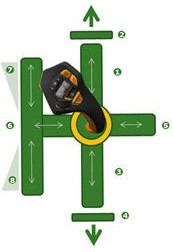 Driving strategy
Driving strategy
| Forward movement | Reverse movement | |
| 1 | Accelerate | Decelerate |
| 2 | Top set speed | Zero speed |
| 3 | Decelerate | Accelerate |
| 4 | Zero speed | Accelerate |
| 5 | Activate set speed | |
| 6 | Select direction | |
| 7 | Inching speed | |
| 8 | Inching speed | |
NOTE: The CommandPro control is only available on IVT transmissions.
Hydraulic pump options to meet varying flow requirements
 Hydraulic pump and filters
Hydraulic pump and filters
All 8 Family Tractors come standard with an 85-cc displacement integrated hydraulic pump. This pump provides 227.1 L/min (60 gpm) of hydraulic flow.
A dual-pump option, featuring 85-cc and 35-cc displacement hydraulic pumps, is available for all 8R and 8RX Tractors. The dual-pump system provides a hydraulic flow of 318 L/min (84 gpm), ideal for running at lower engine speeds.
Operating the tractor at reduced engine rpm contributes to a quieter cab, reduced fuel usage, and maintains the vacuum while turning and raising the planter on end rows. At 1500 engine rpm with a 318-L/min (84-gpm) system, there will be an available flow of 229 L/min (61 gpm). This is an improvement over an available 162-L/min (43-gpm) flow when operating with a 227-L/min (60-gpm) system at 1500 engine rpm.
SCV flow (approximate) |
||
Engine rpm |
Pump flow (85-cc pump) | High pump flow (85-cc pump + 35-cc optional pump) |
800 |
86 L/min (23 gpm) | 122 L/min (32 gpm) |
1500 |
162 L/min (43 gpm) | 229 L/min (61 gpm) |
1700 |
184 L/min (49 gpm) | 260 L/min (69 gpm) |
1900 |
206 L/min (54 gpm) | 290 L/min (77 gpm) |
2100 |
227 L/min (60 gpm) | 318 L/min (84 gpm) |
The maximum flow through one selective control valve (SCV) with a standard coupler is 132 L/min (35 gpm). A 19.1-mm (3/4-in.) high-flow coupler allows for a maximum flow rate out of one SCV of 153 L/min (40.5 gpm).
The hydraulic system is a closed-center, power-on-demand system using a load-sensing pressure-flow compensated axial piston pump with full-flow charge and flow prioritization for steering and brakes.
The pump outlet pressure available on demand can range from 3000 kPa (435 psi) for track models and 4000 kPa (580 psi) for wheel models at low standby to 20,400 kPa (2958 psi) at high standby.
John Deere Connected Support™ transforms the industry
 Maximizing uptime for John Deere customers through the use of connectivity and technology
Maximizing uptime for John Deere customers through the use of connectivity and technology
John Deere Connected Support is a proactive service approach that utilizes the telematics machine connection to leverage a suite of remote support tools available to improve service efficiency and reduce machine downtime on all 7, 8, and 9 Family Tractors.
- Proactive services that drive more uptime
- In-the-moment services to ensure quality job performance
- Leveraging technology to be more effective and efficient
You know that when you’re in the field the unexpected can happen. When it does, you need a quick resolution. That’s why John Deere equipment is prepared with technology that senses potential issues and can alert you promptly—in the cab or anywhere you are. Better yet, your dealer can receive alerts and connect to your equipment. You know your dealer is always ready to keep you farming – and farming better. Starting with model year 2020, your John Deere tractors will come with a 5-year JDLink™ subscription from the factory that makes this connection possible.
 John Deere Connected Support tools
John Deere Connected Support tools
Stop fearing the unexpected and start planning for it with the following John Deere Connected Support tools.
Gain the advantages of a JDLink™ connected machine
 Monitor machines on the go
Monitor machines on the go
 Connectivity provides data that drives better decisions
Connectivity provides data that drives better decisions
Customer needs and their success is John Deere’s focus. As functionality becomes more accepted and even expected, that functionality moves from being optional to being included with the machine. In model year 2019, AutoTrac™ guidance and documentation was included on machines equipped with a 4600 CommandCenter™ Display. Five years of JDLink is also included with the purchase of all model year 2020 machines equipped with a 4G LTE Modular Telematics Gateway (MTG). The functionality of JDLink on these machines includes everything that was previously included with JDLink Access + Remote Display Access (RDA) and JDLink Connect subscriptions. This added connectivity enables customers to more easily realize the value of a connected machine.
- Easily transfer data and collaborate with trusted advisors to plan your field work quickly. You or your employees can spend more time in the field working rather than sitting on a headland setting up the technology. With a connection between John Deere Operations Center and your machines, changes to field plans occur as needed. Those changes may include changes in varieties, application rates, or machines.
- Better enable data-driven decisions. By using the insights gathered from machines along with the tools in Operations Center (e.g., Field Analyzer, Field Analyzer Beta, and Machine Analyzer) you can understand how your fields are performing and what field plans had an impact. John Deere Operations Center gives you access to more than 100 connected software tools, so you have the ultimate choice of popular industry tools. And, if you don't want to analyze the data yourself, you can share the data with those that help you make decisions to provide the insights you need.
- Report work completed accurately and timely for compliance and billing purposes.
- Increase machine uptime with Connected Support. Your local John Deere dealer can provide remote monitoring services and diagnostics to help keep your machines up and running, reduce your maintenance expenses through early detection of problems, and provide over-the-air software updates for displays, receivers, and controllers.
- Get quick in-field support with RDA. You can monitor your machines from your office computer or a mobile device on the go.
- Remotely manage machines and employees to give you insights into how they are performing. If machines are being underutilized or field operations are not being properly conducted, you can put plans in place to improve productivity.
- Quickly make changes to improve your harvesting operations by remotely viewing and adjusting combine settings.
To use JDLink, the following is required:
- MTG
- An active JDLink subscription
- A John Deere Operations Center account to access machine and agronomic data
Take advantage of the Generation 4 CommandCenter™ display, designed for efficiency
The Generation 4 CommandCenter was designed to provide a consistent user experience by providing full-screen viewing of more run page modules, shortcut keys, and precision agriculture capabilities.
Expect easier set-up, along with increased operator confidence, thanks to a simple, customizable interface. The improved design of the Generation 4 CommandCenter also aids in an optimal operating experience and maximizes uptime.
In order to increase your efficiency, take advantage of the following features offered by the Generation 4 CommandCenter:
Layout manager
 Layout manager selection page
Layout manager selection page
 Layout manager module build
Layout manager module build
- Easily create page views that meet your needs and that are also equipped with default run pages.
- Users and access allow the owner or manager to lock out certain functions to prevent operators from accessing or changing settings with a defined four-digit code.
- Gather on-screen help by selecting the help icon on the shortcut bar on the bottom of every page.
Machine monitor
 Machine monitor page
Machine monitor page
- The Machine Monitor application provides you instantaneous readings about the status or condition of your machine.
- This application shows parameters such as engine speed, coolant temperature, and ground speed.
Work monitor
 Work monitor page
Work monitor page
- The Work Monitor application displays performance information about the task being performed by the machine.
- You are shown averages, totals, and productivity of the machine, such as area worked, average working speed, and fuel usage.
- Work setup places the settings needed to properly setup features such as AutoTrac, Documentation, and Section Control in a single location. Settings include:
- Client, farm, and field
- Crop type
- Machine and implement dimensions
- Variety/hybrid and planting/seeding rates
- Variable rate prescriptions
- Product and application rates
- Application rates through the implement screens
Video capability
- Machines equipped with a 4200 CommandCenter are equipped with one video input, and the 4600 CommandCenter has four video inputs.
- You have the ability to set a variety of triggers. With each trigger, the image will then appear on the display.
Flags
 Create flags to mark items in the field
Create flags to mark items in the field
- Mark areas in the field that need special attention such as rocks, tile lines, or weed pressure.
- Flags previously recorded on the Gen 4 or GreenStar™ 3 2630 Display can be transferred between monitors.
- Flags previously recorded on the Gen 4 or GreenStar™ 3 2630 Display can be transferred between monitors.
Field boundaries
 Boundary creation from coverage
Boundary creation from coverage
 Headland creation
Headland creation
- Manually drive field boundaries with the Generation 4 CommandCenter or import existing boundary information from the GreenStar 3 2630 Display or John Deere Operations Center. Gen 4 documentation data can be used to create boundaries from coverage within the John Deere Operations Center.
Dual-display mode
 Dual display
Dual display
- Generation 4 CommandCenter may be configured to run with the following John Deere displays connected at the cornerpost of a John Deere tractor:
- GreenStar 2 1800 Display
- GreenStar 2 2600 Display
- GreenStar 3 2630 Display
- 4640 Universal Display
- 4240 Universal Display
NOTE: Vehicle applications will always be located on the Gen 4 CommandCenter.
Automatic base station switching
 Setup base stations in Fields and Boundaries applications
Setup base stations in Fields and Boundaries applications
- Customers using John Deere RTK Radio 450 or 900 can link a base station to a desired client,/ farm,/ or field. This allows automatic switching to the associated base station when changing fields. The ability to import base station assignments into Operations Center and send back to machines will be available at a later date.
Video looping supported with Gen 4 4600 CommandCenter Display and 4640 Universal Display
 Scan through videos with video looping
Scan through videos with video looping
- This feature enables users to scan or loop through all of the available video feeds for a specified duration. The default scan time is set to 7 seconds per image. The scan time is customizable per image allowing for consistent visibility to all video feeds.
Simple turnkey experience with the StarFire™ 6000 Integrated Receiver
 StarFire 6000 Integrated Receiver
StarFire 6000 Integrated Receiver
The John Deere StarFire™ 6000 Integrated Receiver is the new standard in John Deere Precision Ag technology. The integrated design further enhances the value that you have come to expect from StarFire products.
The StarFire 6000 Integrated Receiver eliminates all setup, installation, and calibrations. There is no need to verify machine and receiver measurements, as this has been done precisely for you at the factory. You will spend 60 minutes less per receiver move each season, which gives you more time to focus on other parts of your operation.
With updated Ethernet connectivity, software updates are easier and faster. StarFire 6000 Integrated Receiver maintains the speed to update software in under 4 minutes while remaining in the cab. Over-the-air updates are 85 percent faster with the StarFire 6000 Integrated Receiver because of Ethernet connectivity.
Features
Experience the ultimate in comfort with the Ultimate Comfort and Convenience package
 Ultimate Comfort and Convenience package
Ultimate Comfort and Convenience package
The Ultimate Comfort and Convenience package offers unsurpassed visibility, operator comfort, control placement, and ride and sound quality. Features in this package include:
Controls
- CommandARM™ console with hitch and hydraulic integrated controls
- Air conditioner and heater with automatic temperature controls
- Radio and volume controls
- Hitch control lever lock and selective control lever lock
- Tilt/telescoping steering wheel with position memory
- Auto trac resume button
- iTEC™ engagement buttons
Displays
- 21.3-cm (8.4-in.) 4200 or 26.4-cm (10.4-in.) 4600 Generation 4 CommandCenter™ Display
- Digital cornerpost display with:
- Fuel level gauge, including low fuel warning
- Temperature gauge
- Diesel exhaust fluid (DEF) gauge, including low DEF warning
- Engine rpm
- Transmission commanded gear or wheel speed
- Vehicle system functions, such as iTEC system, that are operating
- Monitor mounts on right-hand front post and rear cab post
Storage
- Storage compartment underneath the instructor seat
- Left-hand ceiling storage compartment
- Refrigerator located on the left side behind the instructor seat
- Beverage holders sized to accommodate various containers
Sound
- Passive noise reduction system
- Premium sound system, including touchscreen radio, smartphone interface, AM/FM/WX, aux and Bluetooth® with voice control, inputs, XM® ready, six speakers with one subwoofer, and business band ready
Outlets
- Three 12-V convenience outlet (cigarette lighter style)
- Six 12-V three-pin outlet with adapter (provides switched and unswitched power)
- Four charging USB ports
- 120-V AC power outlet
- One International Organization for Standardization (ISO) nine-pin connector
- Power strip with convenience plug adapter
- Service ADVISOR™ data port
Mirrors
- Inside-mounted rearview mirror
- Right and left outside mirrors (manually adjustable mirror head)
Windows
- Swing-out rear window that opens 30 degrees
- Laminated glass
- Two-speed and intermittent front, rear, and right-hand side wiper with washer
- Front, left and right-hand side, and rear pull-down sunshade
Lights
- Interior dome light in the ceiling
- Map lights
For additional attachments and mounting solutions, see Cab convenience or Cab mounting solutions.
Seat
 Leather seat
Leather seat
The seat improves ride quality and helps to reduce operator fatigue.
Features include:
- Leather
- Heat and ventilation to keep the operator at a comfortable temperature
- Adjustable bolsters
- Massage functionality
- Electronic controls to adjust to operator preference
- Pneumatic lumbar adjustment
- Seat height adjustments conveniently located below the left armrest
- Fore-aft adjustment is easy to reach, located below the left armrest
- Cushion length adjustment to get the perfect fit
- Swivel adjustment, located on the front of the seat, allows the seat to be swiveled 40 degrees to the right or 25 degrees to the left of the center position with a pivoting CommandARM console
- Seat can be configured with air seat suspension, ActiveSeat™ II suspension or air seat plus cab suspension
- Operator presence switch warns if the operator is out of the seat while operating key functions
- Seat belt retractor
- Centered cab seat provides excellent over-shoulder visibility
- Adjustable shock absorber permits ride adjustment from soft to firm to match the operator's desired comfort level
- Removable cushions allow for easy cleaning
- Folding instructional seat
Bluetooth is a trademark of Bluetooth SIG, Inc. XM is a trademark of Sirius XM Radio, Inc.
Get 360 degrees of coverage for maximum productivity with visibility packages
 Ultimate Visibility package
Ultimate Visibility package
Visibility is one of the most important attributes of the cab. While lighting is a large portion of that, features like windshield wipers, mirrors, sunshades, and cameras are also important to overall visibility. For this reason, John Deere offers three visibility packages on 7 and 8 Family Tractors:
- Select
- Premium
- Ultimate
Lighting
The lighting configurations are available to match various applications and ensure maximum around-the-clock productivity.
Light housings are large, allowing for optimum total lumens and available light. The Select Visibility package uses 65-W halogen bulbs, whereas the Premium and Ultimate Visibility packages use light-emitting diode (LED) lights. The Premium and Ultimate Visibility packages replace Select Visibility package’s halogen lights with LED lights. The only lights that are not LED are the low-beam driving lights; they remain halogen. This allows each LED light to work at a lower temperature and no one light works harder than any other. The uniformity in LED coverage allows only one type of light output surrounding the tractor.
The lighting pattern in the Ultimate Visibility package provides industry-leading performance in nighttime visibility. LED lights provide maximum brightness and a true color output for excellent field definition that is easy on the operator's eyes.
The LED lights provide 40 percent greater coverage width and 10 percent more light coverage in the rear. LED lighting packages use 45 percent less amps than standard halogen lights and have an increased life expectancy over HID lights which leads to lower costs of ownership over the life of the tractor.
The low- and high-beam driving/work lights are adjustable. Please refer to the electrical section in the Operator’s Manual for complete details on adjusting lights.
NOTE: Lighting packages may vary depending on region.
Efficiency and comfort in the palm of your hand using CommandPRO™ control
 CommandARM™ console with CommandPRO control
CommandARM™ console with CommandPRO control
The unique driving strategy is designed to deliver highest performance in combination with operator comfort making the daily work much easier and efficient.
Driving strategy
- Pedal and joystick mode are active at the same time
- ActiveZero keeps the output speed actively at 0 km/h (0 mph) until command for acceleration is given independent of load or engine speed
- Command top and zero speed simply by one push or pull
- Unique inching control
- Three easily adjustable travel set speeds
- Two engine set speeds
- Three acceleration response settings
 Driving strategy
Driving strategy
| Forward movement | Reverse movement | |
| 1 | Accelerate | Decelerate |
| 2 | Top set speed | Zero speed |
| 3 | Decelerate | Accelerate |
| 4 | Zero speed | Accelerate |
| 5 | Activate set speed | |
| 6 | Select direction | |
| 7 | Inching speed | |
| 8 | Inching speed | |
NOTE: The CommandPro control is only available on IVT transmissions.
Hydraulic pump options to meet varying flow requirements
 Hydraulic pump and filters
Hydraulic pump and filters
All 8 Family Tractors come standard with an 85-cc displacement integrated hydraulic pump. This pump provides 227.1 L/min (60 gpm) of hydraulic flow.
A dual-pump option, featuring 85-cc and 35-cc displacement hydraulic pumps, is available for all 8R and 8RX Tractors. The dual-pump system provides a hydraulic flow of 318 L/min (84 gpm), ideal for running at lower engine speeds.
Operating the tractor at reduced engine rpm contributes to a quieter cab, reduced fuel usage, and maintains the vacuum while turning and raising the planter on end rows. At 1500 engine rpm with a 318-L/min (84-gpm) system, there will be an available flow of 229 L/min (61 gpm). This is an improvement over an available 162-L/min (43-gpm) flow when operating with a 227-L/min (60-gpm) system at 1500 engine rpm.
SCV flow (approximate) |
||
Engine rpm |
Pump flow (85-cc pump) | High pump flow (85-cc pump + 35-cc optional pump) |
800 |
86 L/min (23 gpm) | 122 L/min (32 gpm) |
1500 |
162 L/min (43 gpm) | 229 L/min (61 gpm) |
1700 |
184 L/min (49 gpm) | 260 L/min (69 gpm) |
1900 |
206 L/min (54 gpm) | 290 L/min (77 gpm) |
2100 |
227 L/min (60 gpm) | 318 L/min (84 gpm) |
The maximum flow through one selective control valve (SCV) with a standard coupler is 132 L/min (35 gpm). A 19.1-mm (3/4-in.) high-flow coupler allows for a maximum flow rate out of one SCV of 153 L/min (40.5 gpm).
The hydraulic system is a closed-center, power-on-demand system using a load-sensing pressure-flow compensated axial piston pump with full-flow charge and flow prioritization for steering and brakes.
The pump outlet pressure available on demand can range from 3000 kPa (435 psi) for track models and 4000 kPa (580 psi) for wheel models at low standby to 20,400 kPa (2958 psi) at high standby.
John Deere Connected Support™ transforms the industry
 Maximizing uptime for John Deere customers through the use of connectivity and technology
Maximizing uptime for John Deere customers through the use of connectivity and technology
John Deere Connected Support is a proactive service approach that utilizes the telematics machine connection to leverage a suite of remote support tools available to improve service efficiency and reduce machine downtime on all 7, 8, and 9 Family Tractors.
- Proactive services that drive more uptime
- In-the-moment services to ensure quality job performance
- Leveraging technology to be more effective and efficient
You know that when you’re in the field the unexpected can happen. When it does, you need a quick resolution. That’s why John Deere equipment is prepared with technology that senses potential issues and can alert you promptly—in the cab or anywhere you are. Better yet, your dealer can receive alerts and connect to your equipment. You know your dealer is always ready to keep you farming – and farming better. Starting with model year 2020, your John Deere tractors will come with a 5-year JDLink™ subscription from the factory that makes this connection possible.
 John Deere Connected Support tools
John Deere Connected Support tools
Stop fearing the unexpected and start planning for it with the following John Deere Connected Support tools.
Gain the advantages of a JDLink™ connected machine
 Monitor machines on the go
Monitor machines on the go
 Connectivity provides data that drives better decisions
Connectivity provides data that drives better decisions
Customer needs and their success is John Deere’s focus. As functionality becomes more accepted and even expected, that functionality moves from being optional to being included with the machine. In model year 2019, AutoTrac™ guidance and documentation was included on machines equipped with a 4600 CommandCenter™ Display. Five years of JDLink is also included with the purchase of all model year 2020 machines equipped with a 4G LTE Modular Telematics Gateway (MTG). The functionality of JDLink on these machines includes everything that was previously included with JDLink Access + Remote Display Access (RDA) and JDLink Connect subscriptions. This added connectivity enables customers to more easily realize the value of a connected machine.
- Easily transfer data and collaborate with trusted advisors to plan your field work quickly. You or your employees can spend more time in the field working rather than sitting on a headland setting up the technology. With a connection between John Deere Operations Center and your machines, changes to field plans occur as needed. Those changes may include changes in varieties, application rates, or machines.
- Better enable data-driven decisions. By using the insights gathered from machines along with the tools in Operations Center (e.g., Field Analyzer, Field Analyzer Beta, and Machine Analyzer) you can understand how your fields are performing and what field plans had an impact. John Deere Operations Center gives you access to more than 100 connected software tools, so you have the ultimate choice of popular industry tools. And, if you don't want to analyze the data yourself, you can share the data with those that help you make decisions to provide the insights you need.
- Report work completed accurately and timely for compliance and billing purposes.
- Increase machine uptime with Connected Support. Your local John Deere dealer can provide remote monitoring services and diagnostics to help keep your machines up and running, reduce your maintenance expenses through early detection of problems, and provide over-the-air software updates for displays, receivers, and controllers.
- Get quick in-field support with RDA. You can monitor your machines from your office computer or a mobile device on the go.
- Remotely manage machines and employees to give you insights into how they are performing. If machines are being underutilized or field operations are not being properly conducted, you can put plans in place to improve productivity.
- Quickly make changes to improve your harvesting operations by remotely viewing and adjusting combine settings.
To use JDLink, the following is required:
- MTG
- An active JDLink subscription
- A John Deere Operations Center account to access machine and agronomic data
Take advantage of the Generation 4 CommandCenter™ display, designed for efficiency
The Generation 4 CommandCenter was designed to provide a consistent user experience by providing full-screen viewing of more run page modules, shortcut keys, and precision agriculture capabilities.
Expect easier set-up, along with increased operator confidence, thanks to a simple, customizable interface. The improved design of the Generation 4 CommandCenter also aids in an optimal operating experience and maximizes uptime.
In order to increase your efficiency, take advantage of the following features offered by the Generation 4 CommandCenter:
Layout manager
 Layout manager selection page
Layout manager selection page
 Layout manager module build
Layout manager module build
- Easily create page views that meet your needs and that are also equipped with default run pages.
- Users and access allow the owner or manager to lock out certain functions to prevent operators from accessing or changing settings with a defined four-digit code.
- Gather on-screen help by selecting the help icon on the shortcut bar on the bottom of every page.
Machine monitor
 Machine monitor page
Machine monitor page
- The Machine Monitor application provides you instantaneous readings about the status or condition of your machine.
- This application shows parameters such as engine speed, coolant temperature, and ground speed.
Work monitor
 Work monitor page
Work monitor page
- The Work Monitor application displays performance information about the task being performed by the machine.
- You are shown averages, totals, and productivity of the machine, such as area worked, average working speed, and fuel usage.
- Work setup places the settings needed to properly setup features such as AutoTrac, Documentation, and Section Control in a single location. Settings include:
- Client, farm, and field
- Crop type
- Machine and implement dimensions
- Variety/hybrid and planting/seeding rates
- Variable rate prescriptions
- Product and application rates
- Application rates through the implement screens
Video capability
- Machines equipped with a 4200 CommandCenter are equipped with one video input, and the 4600 CommandCenter has four video inputs.
- You have the ability to set a variety of triggers. With each trigger, the image will then appear on the display.
Flags
 Create flags to mark items in the field
Create flags to mark items in the field
- Mark areas in the field that need special attention such as rocks, tile lines, or weed pressure.
- Flags previously recorded on the Gen 4 or GreenStar™ 3 2630 Display can be transferred between monitors.
- Flags previously recorded on the Gen 4 or GreenStar™ 3 2630 Display can be transferred between monitors.
Field boundaries
 Boundary creation from coverage
Boundary creation from coverage
 Headland creation
Headland creation
- Manually drive field boundaries with the Generation 4 CommandCenter or import existing boundary information from the GreenStar 3 2630 Display or John Deere Operations Center. Gen 4 documentation data can be used to create boundaries from coverage within the John Deere Operations Center.
Dual-display mode
 Dual display
Dual display
- Generation 4 CommandCenter may be configured to run with the following John Deere displays connected at the cornerpost of a John Deere tractor:
- GreenStar 2 1800 Display
- GreenStar 2 2600 Display
- GreenStar 3 2630 Display
- 4640 Universal Display
- 4240 Universal Display
NOTE: Vehicle applications will always be located on the Gen 4 CommandCenter.
Automatic base station switching
 Setup base stations in Fields and Boundaries applications
Setup base stations in Fields and Boundaries applications
- Customers using John Deere RTK Radio 450 or 900 can link a base station to a desired client,/ farm,/ or field. This allows automatic switching to the associated base station when changing fields. The ability to import base station assignments into Operations Center and send back to machines will be available at a later date.
Video looping supported with Gen 4 4600 CommandCenter Display and 4640 Universal Display
 Scan through videos with video looping
Scan through videos with video looping
- This feature enables users to scan or loop through all of the available video feeds for a specified duration. The default scan time is set to 7 seconds per image. The scan time is customizable per image allowing for consistent visibility to all video feeds.
Simple turnkey experience with the StarFire™ 6000 Integrated Receiver
 StarFire 6000 Integrated Receiver
StarFire 6000 Integrated Receiver
The John Deere StarFire™ 6000 Integrated Receiver is the new standard in John Deere Precision Ag technology. The integrated design further enhances the value that you have come to expect from StarFire products.
The StarFire 6000 Integrated Receiver eliminates all setup, installation, and calibrations. There is no need to verify machine and receiver measurements, as this has been done precisely for you at the factory. You will spend 60 minutes less per receiver move each season, which gives you more time to focus on other parts of your operation.
With updated Ethernet connectivity, software updates are easier and faster. StarFire 6000 Integrated Receiver maintains the speed to update software in under 4 minutes while remaining in the cab. Over-the-air updates are 85 percent faster with the StarFire 6000 Integrated Receiver because of Ethernet connectivity.
Features
Experience the ultimate in comfort with the Ultimate Comfort and Convenience package
 Ultimate Comfort and Convenience package
Ultimate Comfort and Convenience package
The Ultimate Comfort and Convenience package offers unsurpassed visibility, operator comfort, control placement, and ride and sound quality. Features in this package include:
Controls
- CommandARM™ console with hitch and hydraulic integrated controls
- Air conditioner and heater with automatic temperature controls
- Radio and volume controls
- Hitch control lever lock and selective control lever lock
- Tilt/telescoping steering wheel with position memory
- Auto trac resume button
- iTEC™ engagement buttons
Displays
- 21.3-cm (8.4-in.) 4200 or 26.4-cm (10.4-in.) 4600 Generation 4 CommandCenter™ Display
- Digital cornerpost display with:
- Fuel level gauge, including low fuel warning
- Temperature gauge
- Diesel exhaust fluid (DEF) gauge, including low DEF warning
- Engine rpm
- Transmission commanded gear or wheel speed
- Vehicle system functions, such as iTEC system, that are operating
- Monitor mounts on right-hand front post and rear cab post
Storage
- Storage compartment underneath the instructor seat
- Left-hand ceiling storage compartment
- Refrigerator located on the left side behind the instructor seat
- Beverage holders sized to accommodate various containers
Sound
- Passive noise reduction system
- Premium sound system, including touchscreen radio, smartphone interface, AM/FM/WX, aux and Bluetooth® with voice control, inputs, XM® ready, six speakers with one subwoofer, and business band ready
Outlets
- Three 12-V convenience outlet (cigarette lighter style)
- Six 12-V three-pin outlet with adapter (provides switched and unswitched power)
- Four charging USB ports
- 120-V AC power outlet
- One International Organization for Standardization (ISO) nine-pin connector
- Power strip with convenience plug adapter
- Service ADVISOR™ data port
Mirrors
- Inside-mounted rearview mirror
- Right and left outside mirrors (manually adjustable mirror head)
Windows
- Swing-out rear window that opens 30 degrees
- Laminated glass
- Two-speed and intermittent front, rear, and right-hand side wiper with washer
- Front, left and right-hand side, and rear pull-down sunshade
Lights
- Interior dome light in the ceiling
- Map lights
For additional attachments and mounting solutions, see Cab convenience or Cab mounting solutions.
Seat
 Leather seat
Leather seat
The seat improves ride quality and helps to reduce operator fatigue.
Features include:
- Leather
- Heat and ventilation to keep the operator at a comfortable temperature
- Adjustable bolsters
- Massage functionality
- Electronic controls to adjust to operator preference
- Pneumatic lumbar adjustment
- Seat height adjustments conveniently located below the left armrest
- Fore-aft adjustment is easy to reach, located below the left armrest
- Cushion length adjustment to get the perfect fit
- Swivel adjustment, located on the front of the seat, allows the seat to be swiveled 40 degrees to the right or 25 degrees to the left of the center position with a pivoting CommandARM console
- Seat can be configured with air seat suspension, ActiveSeat™ II suspension or air seat plus cab suspension
- Operator presence switch warns if the operator is out of the seat while operating key functions
- Seat belt retractor
- Centered cab seat provides excellent over-shoulder visibility
- Adjustable shock absorber permits ride adjustment from soft to firm to match the operator's desired comfort level
- Removable cushions allow for easy cleaning
- Folding instructional seat
Bluetooth is a trademark of Bluetooth SIG, Inc. XM is a trademark of Sirius XM Radio, Inc.
Get 360 degrees of coverage for maximum productivity with visibility packages
 Ultimate Visibility package
Ultimate Visibility package
Visibility is one of the most important attributes of the cab. While lighting is a large portion of that, features like windshield wipers, mirrors, sunshades, and cameras are also important to overall visibility. For this reason, John Deere offers three visibility packages on 7 and 8 Family Tractors:
- Select
- Premium
- Ultimate
Lighting
The lighting configurations are available to match various applications and ensure maximum around-the-clock productivity.
Light housings are large, allowing for optimum total lumens and available light. The Select Visibility package uses 65-W halogen bulbs, whereas the Premium and Ultimate Visibility packages use light-emitting diode (LED) lights. The Premium and Ultimate Visibility packages replace Select Visibility package’s halogen lights with LED lights. The only lights that are not LED are the low-beam driving lights; they remain halogen. This allows each LED light to work at a lower temperature and no one light works harder than any other. The uniformity in LED coverage allows only one type of light output surrounding the tractor.
The lighting pattern in the Ultimate Visibility package provides industry-leading performance in nighttime visibility. LED lights provide maximum brightness and a true color output for excellent field definition that is easy on the operator's eyes.
The LED lights provide 40 percent greater coverage width and 10 percent more light coverage in the rear. LED lighting packages use 45 percent less amps than standard halogen lights and have an increased life expectancy over HID lights which leads to lower costs of ownership over the life of the tractor.
The low- and high-beam driving/work lights are adjustable. Please refer to the electrical section in the Operator’s Manual for complete details on adjusting lights.
NOTE: Lighting packages may vary depending on region.
ActiveSeat™ II seat provides a smoother ride
 ActiveSeat II
ActiveSeat II
The John Deere Active Seat II utilizes an electrical control system to control the vertical seat top movement. The "active" control system minimizes vertical seat top acceleration by sensing vertical tractor inputs and actively positioning the seat top to cancel those inputs. This results in a significantly smoother ride for the operator.
The John Deere ActiveSeat II has many of the same features of the air suspension seat with the addition of a ride firmness switch. The ride firmness switch is located on the left-hand armrest and replaces the suspension shock-dampening seat attenuation lever on the front right-hand side of the seat controls.
The ride firmness switch has three positions: plus, minus, and mid position. The three positions provide three different levels of seat performance:
- The plus position provides the greatest degree of ride firmness. This position allows more of the tractor's inputs to be felt by the operator (slightly rougher ride).
- The minus position provides the least degree of ride firmness, allowing minimal tractor inputs to reach the operator, resulting in maximum seat performance.
- The mid position allows a balance between the plus (+) and minus (-) settings.
 ActiveSeat II left armrest controls
ActiveSeat II left armrest controls
The ActiveSeat II is also available as a heated and ventilated leather seat for increased comfort and easier cleaning. This is only available with the Ultimate Comfort and Convenience package. For tractor applications where operating speed is not limited by the implement, the ActiveSeat II can allow for faster field speeds and increased overall comfort and productivity.
The leather seat includes massaging capability to alleviate operator fatigue.
Right-hand seat swivel has been improved above current 8R Tractors to 25 degrees (versus 8 degrees) to the left and 40 degrees to the right in the Premium and Ultimate Comfort and Convenience packages.
NOTE: The John Deere ActiveSeat II is not available on track tractors.
Efficiency and comfort in the palm of your hand using CommandPRO™ control
 CommandARM™ console with CommandPRO control
CommandARM™ console with CommandPRO control
The unique driving strategy is designed to deliver highest performance in combination with operator comfort making the daily work much easier and efficient.
Driving strategy
- Pedal and joystick mode are active at the same time
- ActiveZero keeps the output speed actively at 0 km/h (0 mph) until command for acceleration is given independent of load or engine speed
- Command top and zero speed simply by one push or pull
- Unique inching control
- Three easily adjustable travel set speeds
- Two engine set speeds
- Three acceleration response settings
 Driving strategy
Driving strategy
| Forward movement | Reverse movement | |
| 1 | Accelerate | Decelerate |
| 2 | Top set speed | Zero speed |
| 3 | Decelerate | Accelerate |
| 4 | Zero speed | Accelerate |
| 5 | Activate set speed | |
| 6 | Select direction | |
| 7 | Inching speed | |
| 8 | Inching speed | |
NOTE: The CommandPro control is only available on IVT transmissions.
Unsurpassed gains in productivity with Independent-Link Suspension (ILS™)
 8R Tractor equipped with ILS
8R Tractor equipped with ILS
 Close-up view of ILS design
Close-up view of ILS design
The John Deere ILS utilizes industry-leading technology to supply unsurpassed gains to end-user productivity. This innovative design incorporates proven suspension design with mechanical front-wheel drive (MFWD) axle components that use state-of-the-art technology specifically for heavy equipment usage. Operators do not have to worry about turning ILS on/off since the John Deere advanced electronic management system knows when to disengage ILS automatically.
The ILS system gets more power to the ground because the front tires maintain ground contact pressure. This improves field and transport ride plus increases ballasting flexibility and drastically decreases the tendency to power hop.
Hydraulic pump options to meet varying flow requirements
 Hydraulic pump and filters
Hydraulic pump and filters
All 8 Family Tractors come standard with an 85-cc displacement integrated hydraulic pump. This pump provides 227.1 L/min (60 gpm) of hydraulic flow.
A dual-pump option, featuring 85-cc and 35-cc displacement hydraulic pumps, is available for all 8R and 8RX Tractors. The dual-pump system provides a hydraulic flow of 318 L/min (84 gpm), ideal for running at lower engine speeds.
Operating the tractor at reduced engine rpm contributes to a quieter cab, reduced fuel usage, and maintains the vacuum while turning and raising the planter on end rows. At 1500 engine rpm with a 318-L/min (84-gpm) system, there will be an available flow of 229 L/min (61 gpm). This is an improvement over an available 162-L/min (43-gpm) flow when operating with a 227-L/min (60-gpm) system at 1500 engine rpm.
SCV flow (approximate) |
||
Engine rpm |
Pump flow (85-cc pump) | High pump flow (85-cc pump + 35-cc optional pump) |
800 |
86 L/min (23 gpm) | 122 L/min (32 gpm) |
1500 |
162 L/min (43 gpm) | 229 L/min (61 gpm) |
1700 |
184 L/min (49 gpm) | 260 L/min (69 gpm) |
1900 |
206 L/min (54 gpm) | 290 L/min (77 gpm) |
2100 |
227 L/min (60 gpm) | 318 L/min (84 gpm) |
The maximum flow through one selective control valve (SCV) with a standard coupler is 132 L/min (35 gpm). A 19.1-mm (3/4-in.) high-flow coupler allows for a maximum flow rate out of one SCV of 153 L/min (40.5 gpm).
The hydraulic system is a closed-center, power-on-demand system using a load-sensing pressure-flow compensated axial piston pump with full-flow charge and flow prioritization for steering and brakes.
The pump outlet pressure available on demand can range from 3000 kPa (435 psi) for track models and 4000 kPa (580 psi) for wheel models at low standby to 20,400 kPa (2958 psi) at high standby.
John Deere Connected Support™ transforms the industry
 Maximizing uptime for John Deere customers through the use of connectivity and technology
Maximizing uptime for John Deere customers through the use of connectivity and technology
John Deere Connected Support is a proactive service approach that utilizes the telematics machine connection to leverage a suite of remote support tools available to improve service efficiency and reduce machine downtime on all 7, 8, and 9 Family Tractors.
- Proactive services that drive more uptime
- In-the-moment services to ensure quality job performance
- Leveraging technology to be more effective and efficient
You know that when you’re in the field the unexpected can happen. When it does, you need a quick resolution. That’s why John Deere equipment is prepared with technology that senses potential issues and can alert you promptly—in the cab or anywhere you are. Better yet, your dealer can receive alerts and connect to your equipment. You know your dealer is always ready to keep you farming – and farming better. Starting with model year 2020, your John Deere tractors will come with a 5-year JDLink™ subscription from the factory that makes this connection possible.
 John Deere Connected Support tools
John Deere Connected Support tools
Stop fearing the unexpected and start planning for it with the following John Deere Connected Support tools.
Gain the advantages of a JDLink™ connected machine
 Monitor machines on the go
Monitor machines on the go
 Connectivity provides data that drives better decisions
Connectivity provides data that drives better decisions
Customer needs and their success is John Deere’s focus. As functionality becomes more accepted and even expected, that functionality moves from being optional to being included with the machine. In model year 2019, AutoTrac™ guidance and documentation was included on machines equipped with a 4600 CommandCenter™ Display. Five years of JDLink is also included with the purchase of all model year 2020 machines equipped with a 4G LTE Modular Telematics Gateway (MTG). The functionality of JDLink on these machines includes everything that was previously included with JDLink Access + Remote Display Access (RDA) and JDLink Connect subscriptions. This added connectivity enables customers to more easily realize the value of a connected machine.
- Easily transfer data and collaborate with trusted advisors to plan your field work quickly. You or your employees can spend more time in the field working rather than sitting on a headland setting up the technology. With a connection between John Deere Operations Center and your machines, changes to field plans occur as needed. Those changes may include changes in varieties, application rates, or machines.
- Better enable data-driven decisions. By using the insights gathered from machines along with the tools in Operations Center (e.g., Field Analyzer, Field Analyzer Beta, and Machine Analyzer) you can understand how your fields are performing and what field plans had an impact. John Deere Operations Center gives you access to more than 100 connected software tools, so you have the ultimate choice of popular industry tools. And, if you don't want to analyze the data yourself, you can share the data with those that help you make decisions to provide the insights you need.
- Report work completed accurately and timely for compliance and billing purposes.
- Increase machine uptime with Connected Support. Your local John Deere dealer can provide remote monitoring services and diagnostics to help keep your machines up and running, reduce your maintenance expenses through early detection of problems, and provide over-the-air software updates for displays, receivers, and controllers.
- Get quick in-field support with RDA. You can monitor your machines from your office computer or a mobile device on the go.
- Remotely manage machines and employees to give you insights into how they are performing. If machines are being underutilized or field operations are not being properly conducted, you can put plans in place to improve productivity.
- Quickly make changes to improve your harvesting operations by remotely viewing and adjusting combine settings.
To use JDLink, the following is required:
- MTG
- An active JDLink subscription
- A John Deere Operations Center account to access machine and agronomic data
Take advantage of the Generation 4 CommandCenter™ display, designed for efficiency
The Generation 4 CommandCenter was designed to provide a consistent user experience by providing full-screen viewing of more run page modules, shortcut keys, and precision agriculture capabilities.
Expect easier set-up, along with increased operator confidence, thanks to a simple, customizable interface. The improved design of the Generation 4 CommandCenter also aids in an optimal operating experience and maximizes uptime.
In order to increase your efficiency, take advantage of the following features offered by the Generation 4 CommandCenter:
Layout manager
 Layout manager selection page
Layout manager selection page
 Layout manager module build
Layout manager module build
- Easily create page views that meet your needs and that are also equipped with default run pages.
- Users and access allow the owner or manager to lock out certain functions to prevent operators from accessing or changing settings with a defined four-digit code.
- Gather on-screen help by selecting the help icon on the shortcut bar on the bottom of every page.
Machine monitor
 Machine monitor page
Machine monitor page
- The Machine Monitor application provides you instantaneous readings about the status or condition of your machine.
- This application shows parameters such as engine speed, coolant temperature, and ground speed.
Work monitor
 Work monitor page
Work monitor page
- The Work Monitor application displays performance information about the task being performed by the machine.
- You are shown averages, totals, and productivity of the machine, such as area worked, average working speed, and fuel usage.
- Work setup places the settings needed to properly setup features such as AutoTrac, Documentation, and Section Control in a single location. Settings include:
- Client, farm, and field
- Crop type
- Machine and implement dimensions
- Variety/hybrid and planting/seeding rates
- Variable rate prescriptions
- Product and application rates
- Application rates through the implement screens
Video capability
- Machines equipped with a 4200 CommandCenter are equipped with one video input, and the 4600 CommandCenter has four video inputs.
- You have the ability to set a variety of triggers. With each trigger, the image will then appear on the display.
Flags
 Create flags to mark items in the field
Create flags to mark items in the field
- Mark areas in the field that need special attention such as rocks, tile lines, or weed pressure.
- Flags previously recorded on the Gen 4 or GreenStar™ 3 2630 Display can be transferred between monitors.
- Flags previously recorded on the Gen 4 or GreenStar™ 3 2630 Display can be transferred between monitors.
Field boundaries
 Boundary creation from coverage
Boundary creation from coverage
 Headland creation
Headland creation
- Manually drive field boundaries with the Generation 4 CommandCenter or import existing boundary information from the GreenStar 3 2630 Display or John Deere Operations Center. Gen 4 documentation data can be used to create boundaries from coverage within the John Deere Operations Center.
Dual-display mode
 Dual display
Dual display
- Generation 4 CommandCenter may be configured to run with the following John Deere displays connected at the cornerpost of a John Deere tractor:
- GreenStar 2 1800 Display
- GreenStar 2 2600 Display
- GreenStar 3 2630 Display
- 4640 Universal Display
- 4240 Universal Display
NOTE: Vehicle applications will always be located on the Gen 4 CommandCenter.
Automatic base station switching
 Setup base stations in Fields and Boundaries applications
Setup base stations in Fields and Boundaries applications
- Customers using John Deere RTK Radio 450 or 900 can link a base station to a desired client,/ farm,/ or field. This allows automatic switching to the associated base station when changing fields. The ability to import base station assignments into Operations Center and send back to machines will be available at a later date.
Video looping supported with Gen 4 4600 CommandCenter Display and 4640 Universal Display
 Scan through videos with video looping
Scan through videos with video looping
- This feature enables users to scan or loop through all of the available video feeds for a specified duration. The default scan time is set to 7 seconds per image. The scan time is customizable per image allowing for consistent visibility to all video feeds.
Simple turnkey experience with the StarFire™ 6000 Integrated Receiver
 StarFire 6000 Integrated Receiver
StarFire 6000 Integrated Receiver
The John Deere StarFire™ 6000 Integrated Receiver is the new standard in John Deere Precision Ag technology. The integrated design further enhances the value that you have come to expect from StarFire products.
The StarFire 6000 Integrated Receiver eliminates all setup, installation, and calibrations. There is no need to verify machine and receiver measurements, as this has been done precisely for you at the factory. You will spend 60 minutes less per receiver move each season, which gives you more time to focus on other parts of your operation.
With updated Ethernet connectivity, software updates are easier and faster. StarFire 6000 Integrated Receiver maintains the speed to update software in under 4 minutes while remaining in the cab. Over-the-air updates are 85 percent faster with the StarFire 6000 Integrated Receiver because of Ethernet connectivity.
Features
Experience the ultimate in comfort with the Ultimate Comfort and Convenience package
 Ultimate Comfort and Convenience package
Ultimate Comfort and Convenience package
The Ultimate Comfort and Convenience package offers unsurpassed visibility, operator comfort, control placement, and ride and sound quality. Features in this package include:
Controls
- CommandARM™ console with hitch and hydraulic integrated controls
- Air conditioner and heater with automatic temperature controls
- Radio and volume controls
- Hitch control lever lock and selective control lever lock
- Tilt/telescoping steering wheel with position memory
- Auto trac resume button
- iTEC™ engagement buttons
Displays
- 21.3-cm (8.4-in.) 4200 or 26.4-cm (10.4-in.) 4600 Generation 4 CommandCenter™ Display
- Digital cornerpost display with:
- Fuel level gauge, including low fuel warning
- Temperature gauge
- Diesel exhaust fluid (DEF) gauge, including low DEF warning
- Engine rpm
- Transmission commanded gear or wheel speed
- Vehicle system functions, such as iTEC system, that are operating
- Monitor mounts on right-hand front post and rear cab post
Storage
- Storage compartment underneath the instructor seat
- Left-hand ceiling storage compartment
- Refrigerator located on the left side behind the instructor seat
- Beverage holders sized to accommodate various containers
Sound
- Passive noise reduction system
- Premium sound system, including touchscreen radio, smartphone interface, AM/FM/WX, aux and Bluetooth® with voice control, inputs, XM® ready, six speakers with one subwoofer, and business band ready
Outlets
- Three 12-V convenience outlet (cigarette lighter style)
- Six 12-V three-pin outlet with adapter (provides switched and unswitched power)
- Four charging USB ports
- 120-V AC power outlet
- One International Organization for Standardization (ISO) nine-pin connector
- Power strip with convenience plug adapter
- Service ADVISOR™ data port
Mirrors
- Inside-mounted rearview mirror
- Right and left outside mirrors (manually adjustable mirror head)
Windows
- Swing-out rear window that opens 30 degrees
- Laminated glass
- Two-speed and intermittent front, rear, and right-hand side wiper with washer
- Front, left and right-hand side, and rear pull-down sunshade
Lights
- Interior dome light in the ceiling
- Map lights
For additional attachments and mounting solutions, see Cab convenience or Cab mounting solutions.
Seat
 Leather seat
Leather seat
The seat improves ride quality and helps to reduce operator fatigue.
Features include:
- Leather
- Heat and ventilation to keep the operator at a comfortable temperature
- Adjustable bolsters
- Massage functionality
- Electronic controls to adjust to operator preference
- Pneumatic lumbar adjustment
- Seat height adjustments conveniently located below the left armrest
- Fore-aft adjustment is easy to reach, located below the left armrest
- Cushion length adjustment to get the perfect fit
- Swivel adjustment, located on the front of the seat, allows the seat to be swiveled 40 degrees to the right or 25 degrees to the left of the center position with a pivoting CommandARM console
- Seat can be configured with air seat suspension, ActiveSeat™ II suspension or air seat plus cab suspension
- Operator presence switch warns if the operator is out of the seat while operating key functions
- Seat belt retractor
- Centered cab seat provides excellent over-shoulder visibility
- Adjustable shock absorber permits ride adjustment from soft to firm to match the operator's desired comfort level
- Removable cushions allow for easy cleaning
- Folding instructional seat
Bluetooth is a trademark of Bluetooth SIG, Inc. XM is a trademark of Sirius XM Radio, Inc.
Get 360 degrees of coverage for maximum productivity with visibility packages
 Ultimate Visibility package
Ultimate Visibility package
Visibility is one of the most important attributes of the cab. While lighting is a large portion of that, features like windshield wipers, mirrors, sunshades, and cameras are also important to overall visibility. For this reason, John Deere offers three visibility packages on 7 and 8 Family Tractors:
- Select
- Premium
- Ultimate
Lighting
The lighting configurations are available to match various applications and ensure maximum around-the-clock productivity.
Light housings are large, allowing for optimum total lumens and available light. The Select Visibility package uses 65-W halogen bulbs, whereas the Premium and Ultimate Visibility packages use light-emitting diode (LED) lights. The Premium and Ultimate Visibility packages replace Select Visibility package’s halogen lights with LED lights. The only lights that are not LED are the low-beam driving lights; they remain halogen. This allows each LED light to work at a lower temperature and no one light works harder than any other. The uniformity in LED coverage allows only one type of light output surrounding the tractor.
The lighting pattern in the Ultimate Visibility package provides industry-leading performance in nighttime visibility. LED lights provide maximum brightness and a true color output for excellent field definition that is easy on the operator's eyes.
The LED lights provide 40 percent greater coverage width and 10 percent more light coverage in the rear. LED lighting packages use 45 percent less amps than standard halogen lights and have an increased life expectancy over HID lights which leads to lower costs of ownership over the life of the tractor.
The low- and high-beam driving/work lights are adjustable. Please refer to the electrical section in the Operator’s Manual for complete details on adjusting lights.
NOTE: Lighting packages may vary depending on region.
Efficiency and comfort in the palm of your hand using CommandPRO™ control
 CommandARM™ console with CommandPRO control
CommandARM™ console with CommandPRO control
The unique driving strategy is designed to deliver highest performance in combination with operator comfort making the daily work much easier and efficient.
Driving strategy
- Pedal and joystick mode are active at the same time
- ActiveZero keeps the output speed actively at 0 km/h (0 mph) until command for acceleration is given independent of load or engine speed
- Command top and zero speed simply by one push or pull
- Unique inching control
- Three easily adjustable travel set speeds
- Two engine set speeds
- Three acceleration response settings
 Driving strategy
Driving strategy
| Forward movement | Reverse movement | |
| 1 | Accelerate | Decelerate |
| 2 | Top set speed | Zero speed |
| 3 | Decelerate | Accelerate |
| 4 | Zero speed | Accelerate |
| 5 | Activate set speed | |
| 6 | Select direction | |
| 7 | Inching speed | |
| 8 | Inching speed | |
NOTE: The CommandPro control is only available on IVT transmissions.
Hydraulic pump options to meet varying flow requirements
 Hydraulic pump and filters
Hydraulic pump and filters
All 8 Family Tractors come standard with an 85-cc displacement integrated hydraulic pump. This pump provides 227.1 L/min (60 gpm) of hydraulic flow.
A dual-pump option, featuring 85-cc and 35-cc displacement hydraulic pumps, is available for all 8R and 8RX Tractors. The dual-pump system provides a hydraulic flow of 318 L/min (84 gpm), ideal for running at lower engine speeds.
Operating the tractor at reduced engine rpm contributes to a quieter cab, reduced fuel usage, and maintains the vacuum while turning and raising the planter on end rows. At 1500 engine rpm with a 318-L/min (84-gpm) system, there will be an available flow of 229 L/min (61 gpm). This is an improvement over an available 162-L/min (43-gpm) flow when operating with a 227-L/min (60-gpm) system at 1500 engine rpm.
SCV flow (approximate) |
||
Engine rpm |
Pump flow (85-cc pump) | High pump flow (85-cc pump + 35-cc optional pump) |
800 |
86 L/min (23 gpm) | 122 L/min (32 gpm) |
1500 |
162 L/min (43 gpm) | 229 L/min (61 gpm) |
1700 |
184 L/min (49 gpm) | 260 L/min (69 gpm) |
1900 |
206 L/min (54 gpm) | 290 L/min (77 gpm) |
2100 |
227 L/min (60 gpm) | 318 L/min (84 gpm) |
The maximum flow through one selective control valve (SCV) with a standard coupler is 132 L/min (35 gpm). A 19.1-mm (3/4-in.) high-flow coupler allows for a maximum flow rate out of one SCV of 153 L/min (40.5 gpm).
The hydraulic system is a closed-center, power-on-demand system using a load-sensing pressure-flow compensated axial piston pump with full-flow charge and flow prioritization for steering and brakes.
The pump outlet pressure available on demand can range from 3000 kPa (435 psi) for track models and 4000 kPa (580 psi) for wheel models at low standby to 20,400 kPa (2958 psi) at high standby.
John Deere Connected Support™ transforms the industry
 Maximizing uptime for John Deere customers through the use of connectivity and technology
Maximizing uptime for John Deere customers through the use of connectivity and technology
John Deere Connected Support is a proactive service approach that utilizes the telematics machine connection to leverage a suite of remote support tools available to improve service efficiency and reduce machine downtime on all 7, 8, and 9 Family Tractors.
- Proactive services that drive more uptime
- In-the-moment services to ensure quality job performance
- Leveraging technology to be more effective and efficient
You know that when you’re in the field the unexpected can happen. When it does, you need a quick resolution. That’s why John Deere equipment is prepared with technology that senses potential issues and can alert you promptly—in the cab or anywhere you are. Better yet, your dealer can receive alerts and connect to your equipment. You know your dealer is always ready to keep you farming – and farming better. Starting with model year 2020, your John Deere tractors will come with a 5-year JDLink™ subscription from the factory that makes this connection possible.
 John Deere Connected Support tools
John Deere Connected Support tools
Stop fearing the unexpected and start planning for it with the following John Deere Connected Support tools.
Gain the advantages of a JDLink™ connected machine
 Monitor machines on the go
Monitor machines on the go
 Connectivity provides data that drives better decisions
Connectivity provides data that drives better decisions
Customer needs and their success is John Deere’s focus. As functionality becomes more accepted and even expected, that functionality moves from being optional to being included with the machine. In model year 2019, AutoTrac™ guidance and documentation was included on machines equipped with a 4600 CommandCenter™ Display. Five years of JDLink is also included with the purchase of all model year 2020 machines equipped with a 4G LTE Modular Telematics Gateway (MTG). The functionality of JDLink on these machines includes everything that was previously included with JDLink Access + Remote Display Access (RDA) and JDLink Connect subscriptions. This added connectivity enables customers to more easily realize the value of a connected machine.
- Easily transfer data and collaborate with trusted advisors to plan your field work quickly. You or your employees can spend more time in the field working rather than sitting on a headland setting up the technology. With a connection between John Deere Operations Center and your machines, changes to field plans occur as needed. Those changes may include changes in varieties, application rates, or machines.
- Better enable data-driven decisions. By using the insights gathered from machines along with the tools in Operations Center (e.g., Field Analyzer, Field Analyzer Beta, and Machine Analyzer) you can understand how your fields are performing and what field plans had an impact. John Deere Operations Center gives you access to more than 100 connected software tools, so you have the ultimate choice of popular industry tools. And, if you don't want to analyze the data yourself, you can share the data with those that help you make decisions to provide the insights you need.
- Report work completed accurately and timely for compliance and billing purposes.
- Increase machine uptime with Connected Support. Your local John Deere dealer can provide remote monitoring services and diagnostics to help keep your machines up and running, reduce your maintenance expenses through early detection of problems, and provide over-the-air software updates for displays, receivers, and controllers.
- Get quick in-field support with RDA. You can monitor your machines from your office computer or a mobile device on the go.
- Remotely manage machines and employees to give you insights into how they are performing. If machines are being underutilized or field operations are not being properly conducted, you can put plans in place to improve productivity.
- Quickly make changes to improve your harvesting operations by remotely viewing and adjusting combine settings.
To use JDLink, the following is required:
- MTG
- An active JDLink subscription
- A John Deere Operations Center account to access machine and agronomic data
Take advantage of the Generation 4 CommandCenter™ display, designed for efficiency
The Generation 4 CommandCenter was designed to provide a consistent user experience by providing full-screen viewing of more run page modules, shortcut keys, and precision agriculture capabilities.
Expect easier set-up, along with increased operator confidence, thanks to a simple, customizable interface. The improved design of the Generation 4 CommandCenter also aids in an optimal operating experience and maximizes uptime.
In order to increase your efficiency, take advantage of the following features offered by the Generation 4 CommandCenter:
Layout manager
 Layout manager selection page
Layout manager selection page
 Layout manager module build
Layout manager module build
- Easily create page views that meet your needs and that are also equipped with default run pages.
- Users and access allow the owner or manager to lock out certain functions to prevent operators from accessing or changing settings with a defined four-digit code.
- Gather on-screen help by selecting the help icon on the shortcut bar on the bottom of every page.
Machine monitor
 Machine monitor page
Machine monitor page
- The Machine Monitor application provides you instantaneous readings about the status or condition of your machine.
- This application shows parameters such as engine speed, coolant temperature, and ground speed.
Work monitor
 Work monitor page
Work monitor page
- The Work Monitor application displays performance information about the task being performed by the machine.
- You are shown averages, totals, and productivity of the machine, such as area worked, average working speed, and fuel usage.
- Work setup places the settings needed to properly setup features such as AutoTrac, Documentation, and Section Control in a single location. Settings include:
- Client, farm, and field
- Crop type
- Machine and implement dimensions
- Variety/hybrid and planting/seeding rates
- Variable rate prescriptions
- Product and application rates
- Application rates through the implement screens
Video capability
- Machines equipped with a 4200 CommandCenter are equipped with one video input, and the 4600 CommandCenter has four video inputs.
- You have the ability to set a variety of triggers. With each trigger, the image will then appear on the display.
Flags
 Create flags to mark items in the field
Create flags to mark items in the field
- Mark areas in the field that need special attention such as rocks, tile lines, or weed pressure.
- Flags previously recorded on the Gen 4 or GreenStar™ 3 2630 Display can be transferred between monitors.
- Flags previously recorded on the Gen 4 or GreenStar™ 3 2630 Display can be transferred between monitors.
Field boundaries
 Boundary creation from coverage
Boundary creation from coverage
 Headland creation
Headland creation
- Manually drive field boundaries with the Generation 4 CommandCenter or import existing boundary information from the GreenStar 3 2630 Display or John Deere Operations Center. Gen 4 documentation data can be used to create boundaries from coverage within the John Deere Operations Center.
Dual-display mode
 Dual display
Dual display
- Generation 4 CommandCenter may be configured to run with the following John Deere displays connected at the cornerpost of a John Deere tractor:
- GreenStar 2 1800 Display
- GreenStar 2 2600 Display
- GreenStar 3 2630 Display
- 4640 Universal Display
- 4240 Universal Display
NOTE: Vehicle applications will always be located on the Gen 4 CommandCenter.
Automatic base station switching
 Setup base stations in Fields and Boundaries applications
Setup base stations in Fields and Boundaries applications
- Customers using John Deere RTK Radio 450 or 900 can link a base station to a desired client,/ farm,/ or field. This allows automatic switching to the associated base station when changing fields. The ability to import base station assignments into Operations Center and send back to machines will be available at a later date.
Video looping supported with Gen 4 4600 CommandCenter Display and 4640 Universal Display
 Scan through videos with video looping
Scan through videos with video looping
- This feature enables users to scan or loop through all of the available video feeds for a specified duration. The default scan time is set to 7 seconds per image. The scan time is customizable per image allowing for consistent visibility to all video feeds.
Simple turnkey experience with the StarFire™ 6000 Integrated Receiver
 StarFire 6000 Integrated Receiver
StarFire 6000 Integrated Receiver
The John Deere StarFire™ 6000 Integrated Receiver is the new standard in John Deere Precision Ag technology. The integrated design further enhances the value that you have come to expect from StarFire products.
The StarFire 6000 Integrated Receiver eliminates all setup, installation, and calibrations. There is no need to verify machine and receiver measurements, as this has been done precisely for you at the factory. You will spend 60 minutes less per receiver move each season, which gives you more time to focus on other parts of your operation.
With updated Ethernet connectivity, software updates are easier and faster. StarFire 6000 Integrated Receiver maintains the speed to update software in under 4 minutes while remaining in the cab. Over-the-air updates are 85 percent faster with the StarFire 6000 Integrated Receiver because of Ethernet connectivity.
Features
Experience the ultimate in comfort with the Ultimate Comfort and Convenience package
 Ultimate Comfort and Convenience package
Ultimate Comfort and Convenience package
The Ultimate Comfort and Convenience package offers unsurpassed visibility, operator comfort, control placement, and ride and sound quality. Features in this package include:
Controls
- CommandARM™ console with hitch and hydraulic integrated controls
- Air conditioner and heater with automatic temperature controls
- Radio and volume controls
- Hitch control lever lock and selective control lever lock
- Tilt/telescoping steering wheel with position memory
- Auto trac resume button
- iTEC™ engagement buttons
Displays
- 21.3-cm (8.4-in.) 4200 or 26.4-cm (10.4-in.) 4600 Generation 4 CommandCenter™ Display
- Digital cornerpost display with:
- Fuel level gauge, including low fuel warning
- Temperature gauge
- Diesel exhaust fluid (DEF) gauge, including low DEF warning
- Engine rpm
- Transmission commanded gear or wheel speed
- Vehicle system functions, such as iTEC system, that are operating
- Monitor mounts on right-hand front post and rear cab post
Storage
- Storage compartment underneath the instructor seat
- Left-hand ceiling storage compartment
- Refrigerator located on the left side behind the instructor seat
- Beverage holders sized to accommodate various containers
Sound
- Passive noise reduction system
- Premium sound system, including touchscreen radio, smartphone interface, AM/FM/WX, aux and Bluetooth® with voice control, inputs, XM® ready, six speakers with one subwoofer, and business band ready
Outlets
- Three 12-V convenience outlet (cigarette lighter style)
- Six 12-V three-pin outlet with adapter (provides switched and unswitched power)
- Four charging USB ports
- 120-V AC power outlet
- One International Organization for Standardization (ISO) nine-pin connector
- Power strip with convenience plug adapter
- Service ADVISOR™ data port
Mirrors
- Inside-mounted rearview mirror
- Right and left outside mirrors (manually adjustable mirror head)
Windows
- Swing-out rear window that opens 30 degrees
- Laminated glass
- Two-speed and intermittent front, rear, and right-hand side wiper with washer
- Front, left and right-hand side, and rear pull-down sunshade
Lights
- Interior dome light in the ceiling
- Map lights
For additional attachments and mounting solutions, see Cab convenience or Cab mounting solutions.
Seat
 Leather seat
Leather seat
The seat improves ride quality and helps to reduce operator fatigue.
Features include:
- Leather
- Heat and ventilation to keep the operator at a comfortable temperature
- Adjustable bolsters
- Massage functionality
- Electronic controls to adjust to operator preference
- Pneumatic lumbar adjustment
- Seat height adjustments conveniently located below the left armrest
- Fore-aft adjustment is easy to reach, located below the left armrest
- Cushion length adjustment to get the perfect fit
- Swivel adjustment, located on the front of the seat, allows the seat to be swiveled 40 degrees to the right or 25 degrees to the left of the center position with a pivoting CommandARM console
- Seat can be configured with air seat suspension, ActiveSeat™ II suspension or air seat plus cab suspension
- Operator presence switch warns if the operator is out of the seat while operating key functions
- Seat belt retractor
- Centered cab seat provides excellent over-shoulder visibility
- Adjustable shock absorber permits ride adjustment from soft to firm to match the operator's desired comfort level
- Removable cushions allow for easy cleaning
- Folding instructional seat
Bluetooth is a trademark of Bluetooth SIG, Inc. XM is a trademark of Sirius XM Radio, Inc.
Get 360 degrees of coverage for maximum productivity with visibility packages
 Ultimate Visibility package
Ultimate Visibility package
Visibility is one of the most important attributes of the cab. While lighting is a large portion of that, features like windshield wipers, mirrors, sunshades, and cameras are also important to overall visibility. For this reason, John Deere offers three visibility packages on 7 and 8 Family Tractors:
- Select
- Premium
- Ultimate
Lighting
The lighting configurations are available to match various applications and ensure maximum around-the-clock productivity.
Light housings are large, allowing for optimum total lumens and available light. The Select Visibility package uses 65-W halogen bulbs, whereas the Premium and Ultimate Visibility packages use light-emitting diode (LED) lights. The Premium and Ultimate Visibility packages replace Select Visibility package’s halogen lights with LED lights. The only lights that are not LED are the low-beam driving lights; they remain halogen. This allows each LED light to work at a lower temperature and no one light works harder than any other. The uniformity in LED coverage allows only one type of light output surrounding the tractor.
The lighting pattern in the Ultimate Visibility package provides industry-leading performance in nighttime visibility. LED lights provide maximum brightness and a true color output for excellent field definition that is easy on the operator's eyes.
The LED lights provide 40 percent greater coverage width and 10 percent more light coverage in the rear. LED lighting packages use 45 percent less amps than standard halogen lights and have an increased life expectancy over HID lights which leads to lower costs of ownership over the life of the tractor.
The low- and high-beam driving/work lights are adjustable. Please refer to the electrical section in the Operator’s Manual for complete details on adjusting lights.
NOTE: Lighting packages may vary depending on region.
Efficiency and comfort in the palm of your hand using CommandPRO™ control
 CommandARM™ console with CommandPRO control
CommandARM™ console with CommandPRO control
The unique driving strategy is designed to deliver highest performance in combination with operator comfort making the daily work much easier and efficient.
Driving strategy
- Pedal and joystick mode are active at the same time
- ActiveZero keeps the output speed actively at 0 km/h (0 mph) until command for acceleration is given independent of load or engine speed
- Command top and zero speed simply by one push or pull
- Unique inching control
- Three easily adjustable travel set speeds
- Two engine set speeds
- Three acceleration response settings
 Driving strategy
Driving strategy
| Forward movement | Reverse movement | |
| 1 | Accelerate | Decelerate |
| 2 | Top set speed | Zero speed |
| 3 | Decelerate | Accelerate |
| 4 | Zero speed | Accelerate |
| 5 | Activate set speed | |
| 6 | Select direction | |
| 7 | Inching speed | |
| 8 | Inching speed | |
NOTE: The CommandPro control is only available on IVT transmissions.
Hydraulic pump options to meet varying flow requirements
 Hydraulic pump and filters
Hydraulic pump and filters
All 8 Family Tractors come standard with an 85-cc displacement integrated hydraulic pump. This pump provides 227.1 L/min (60 gpm) of hydraulic flow.
A dual-pump option, featuring 85-cc and 35-cc displacement hydraulic pumps, is available for all 8R and 8RX Tractors. The dual-pump system provides a hydraulic flow of 318 L/min (84 gpm), ideal for running at lower engine speeds.
Operating the tractor at reduced engine rpm contributes to a quieter cab, reduced fuel usage, and maintains the vacuum while turning and raising the planter on end rows. At 1500 engine rpm with a 318-L/min (84-gpm) system, there will be an available flow of 229 L/min (61 gpm). This is an improvement over an available 162-L/min (43-gpm) flow when operating with a 227-L/min (60-gpm) system at 1500 engine rpm.
SCV flow (approximate) |
||
Engine rpm |
Pump flow (85-cc pump) | High pump flow (85-cc pump + 35-cc optional pump) |
800 |
86 L/min (23 gpm) | 122 L/min (32 gpm) |
1500 |
162 L/min (43 gpm) | 229 L/min (61 gpm) |
1700 |
184 L/min (49 gpm) | 260 L/min (69 gpm) |
1900 |
206 L/min (54 gpm) | 290 L/min (77 gpm) |
2100 |
227 L/min (60 gpm) | 318 L/min (84 gpm) |
The maximum flow through one selective control valve (SCV) with a standard coupler is 132 L/min (35 gpm). A 19.1-mm (3/4-in.) high-flow coupler allows for a maximum flow rate out of one SCV of 153 L/min (40.5 gpm).
The hydraulic system is a closed-center, power-on-demand system using a load-sensing pressure-flow compensated axial piston pump with full-flow charge and flow prioritization for steering and brakes.
The pump outlet pressure available on demand can range from 3000 kPa (435 psi) for track models and 4000 kPa (580 psi) for wheel models at low standby to 20,400 kPa (2958 psi) at high standby.
John Deere Connected Support™ transforms the industry
 Maximizing uptime for John Deere customers through the use of connectivity and technology
Maximizing uptime for John Deere customers through the use of connectivity and technology
John Deere Connected Support is a proactive service approach that utilizes the telematics machine connection to leverage a suite of remote support tools available to improve service efficiency and reduce machine downtime on all 7, 8, and 9 Family Tractors.
- Proactive services that drive more uptime
- In-the-moment services to ensure quality job performance
- Leveraging technology to be more effective and efficient
You know that when you’re in the field the unexpected can happen. When it does, you need a quick resolution. That’s why John Deere equipment is prepared with technology that senses potential issues and can alert you promptly—in the cab or anywhere you are. Better yet, your dealer can receive alerts and connect to your equipment. You know your dealer is always ready to keep you farming – and farming better. Starting with model year 2020, your John Deere tractors will come with a 5-year JDLink™ subscription from the factory that makes this connection possible.
 John Deere Connected Support tools
John Deere Connected Support tools
Stop fearing the unexpected and start planning for it with the following John Deere Connected Support tools.
Gain the advantages of a JDLink™ connected machine
 Monitor machines on the go
Monitor machines on the go
 Connectivity provides data that drives better decisions
Connectivity provides data that drives better decisions
Customer needs and their success is John Deere’s focus. As functionality becomes more accepted and even expected, that functionality moves from being optional to being included with the machine. In model year 2019, AutoTrac™ guidance and documentation was included on machines equipped with a 4600 CommandCenter™ Display. Five years of JDLink is also included with the purchase of all model year 2020 machines equipped with a 4G LTE Modular Telematics Gateway (MTG). The functionality of JDLink on these machines includes everything that was previously included with JDLink Access + Remote Display Access (RDA) and JDLink Connect subscriptions. This added connectivity enables customers to more easily realize the value of a connected machine.
- Easily transfer data and collaborate with trusted advisors to plan your field work quickly. You or your employees can spend more time in the field working rather than sitting on a headland setting up the technology. With a connection between John Deere Operations Center and your machines, changes to field plans occur as needed. Those changes may include changes in varieties, application rates, or machines.
- Better enable data-driven decisions. By using the insights gathered from machines along with the tools in Operations Center (e.g., Field Analyzer, Field Analyzer Beta, and Machine Analyzer) you can understand how your fields are performing and what field plans had an impact. John Deere Operations Center gives you access to more than 100 connected software tools, so you have the ultimate choice of popular industry tools. And, if you don't want to analyze the data yourself, you can share the data with those that help you make decisions to provide the insights you need.
- Report work completed accurately and timely for compliance and billing purposes.
- Increase machine uptime with Connected Support. Your local John Deere dealer can provide remote monitoring services and diagnostics to help keep your machines up and running, reduce your maintenance expenses through early detection of problems, and provide over-the-air software updates for displays, receivers, and controllers.
- Get quick in-field support with RDA. You can monitor your machines from your office computer or a mobile device on the go.
- Remotely manage machines and employees to give you insights into how they are performing. If machines are being underutilized or field operations are not being properly conducted, you can put plans in place to improve productivity.
- Quickly make changes to improve your harvesting operations by remotely viewing and adjusting combine settings.
To use JDLink, the following is required:
- MTG
- An active JDLink subscription
- A John Deere Operations Center account to access machine and agronomic data
Take advantage of the Generation 4 CommandCenter™ display, designed for efficiency
The Generation 4 CommandCenter was designed to provide a consistent user experience by providing full-screen viewing of more run page modules, shortcut keys, and precision agriculture capabilities.
Expect easier set-up, along with increased operator confidence, thanks to a simple, customizable interface. The improved design of the Generation 4 CommandCenter also aids in an optimal operating experience and maximizes uptime.
In order to increase your efficiency, take advantage of the following features offered by the Generation 4 CommandCenter:
Layout manager
 Layout manager selection page
Layout manager selection page
 Layout manager module build
Layout manager module build
- Easily create page views that meet your needs and that are also equipped with default run pages.
- Users and access allow the owner or manager to lock out certain functions to prevent operators from accessing or changing settings with a defined four-digit code.
- Gather on-screen help by selecting the help icon on the shortcut bar on the bottom of every page.
Machine monitor
 Machine monitor page
Machine monitor page
- The Machine Monitor application provides you instantaneous readings about the status or condition of your machine.
- This application shows parameters such as engine speed, coolant temperature, and ground speed.
Work monitor
 Work monitor page
Work monitor page
- The Work Monitor application displays performance information about the task being performed by the machine.
- You are shown averages, totals, and productivity of the machine, such as area worked, average working speed, and fuel usage.
- Work setup places the settings needed to properly setup features such as AutoTrac, Documentation, and Section Control in a single location. Settings include:
- Client, farm, and field
- Crop type
- Machine and implement dimensions
- Variety/hybrid and planting/seeding rates
- Variable rate prescriptions
- Product and application rates
- Application rates through the implement screens
Video capability
- Machines equipped with a 4200 CommandCenter are equipped with one video input, and the 4600 CommandCenter has four video inputs.
- You have the ability to set a variety of triggers. With each trigger, the image will then appear on the display.
Flags
 Create flags to mark items in the field
Create flags to mark items in the field
- Mark areas in the field that need special attention such as rocks, tile lines, or weed pressure.
- Flags previously recorded on the Gen 4 or GreenStar™ 3 2630 Display can be transferred between monitors.
- Flags previously recorded on the Gen 4 or GreenStar™ 3 2630 Display can be transferred between monitors.
Field boundaries
 Boundary creation from coverage
Boundary creation from coverage
 Headland creation
Headland creation
- Manually drive field boundaries with the Generation 4 CommandCenter or import existing boundary information from the GreenStar 3 2630 Display or John Deere Operations Center. Gen 4 documentation data can be used to create boundaries from coverage within the John Deere Operations Center.
Dual-display mode
 Dual display
Dual display
- Generation 4 CommandCenter may be configured to run with the following John Deere displays connected at the cornerpost of a John Deere tractor:
- GreenStar 2 1800 Display
- GreenStar 2 2600 Display
- GreenStar 3 2630 Display
- 4640 Universal Display
- 4240 Universal Display
NOTE: Vehicle applications will always be located on the Gen 4 CommandCenter.
Automatic base station switching
 Setup base stations in Fields and Boundaries applications
Setup base stations in Fields and Boundaries applications
- Customers using John Deere RTK Radio 450 or 900 can link a base station to a desired client,/ farm,/ or field. This allows automatic switching to the associated base station when changing fields. The ability to import base station assignments into Operations Center and send back to machines will be available at a later date.
Video looping supported with Gen 4 4600 CommandCenter Display and 4640 Universal Display
 Scan through videos with video looping
Scan through videos with video looping
- This feature enables users to scan or loop through all of the available video feeds for a specified duration. The default scan time is set to 7 seconds per image. The scan time is customizable per image allowing for consistent visibility to all video feeds.
Simple turnkey experience with the StarFire™ 6000 Integrated Receiver
 StarFire 6000 Integrated Receiver
StarFire 6000 Integrated Receiver
The John Deere StarFire™ 6000 Integrated Receiver is the new standard in John Deere Precision Ag technology. The integrated design further enhances the value that you have come to expect from StarFire products.
The StarFire 6000 Integrated Receiver eliminates all setup, installation, and calibrations. There is no need to verify machine and receiver measurements, as this has been done precisely for you at the factory. You will spend 60 minutes less per receiver move each season, which gives you more time to focus on other parts of your operation.
With updated Ethernet connectivity, software updates are easier and faster. StarFire 6000 Integrated Receiver maintains the speed to update software in under 4 minutes while remaining in the cab. Over-the-air updates are 85 percent faster with the StarFire 6000 Integrated Receiver because of Ethernet connectivity.
Features
Experience the ultimate in comfort with the Ultimate Comfort and Convenience package
 Ultimate Comfort and Convenience package
Ultimate Comfort and Convenience package
The Ultimate Comfort and Convenience package offers unsurpassed visibility, operator comfort, control placement, and ride and sound quality. Features in this package include:
Controls
- CommandARM™ console with hitch and hydraulic integrated controls
- Air conditioner and heater with automatic temperature controls
- Radio and volume controls
- Hitch control lever lock and selective control lever lock
- Tilt/telescoping steering wheel with position memory
- Auto trac resume button
- iTEC™ engagement buttons
Displays
- 21.3-cm (8.4-in.) 4200 or 26.4-cm (10.4-in.) 4600 Generation 4 CommandCenter™ Display
- Digital cornerpost display with:
- Fuel level gauge, including low fuel warning
- Temperature gauge
- Diesel exhaust fluid (DEF) gauge, including low DEF warning
- Engine rpm
- Transmission commanded gear or wheel speed
- Vehicle system functions, such as iTEC system, that are operating
- Monitor mounts on right-hand front post and rear cab post
Storage
- Storage compartment underneath the instructor seat
- Left-hand ceiling storage compartment
- Refrigerator located on the left side behind the instructor seat
- Beverage holders sized to accommodate various containers
Sound
- Passive noise reduction system
- Premium sound system, including touchscreen radio, smartphone interface, AM/FM/WX, aux and Bluetooth® with voice control, inputs, XM® ready, six speakers with one subwoofer, and business band ready
Outlets
- Three 12-V convenience outlet (cigarette lighter style)
- Six 12-V three-pin outlet with adapter (provides switched and unswitched power)
- Four charging USB ports
- 120-V AC power outlet
- One International Organization for Standardization (ISO) nine-pin connector
- Power strip with convenience plug adapter
- Service ADVISOR™ data port
Mirrors
- Inside-mounted rearview mirror
- Right and left outside mirrors (manually adjustable mirror head)
Windows
- Swing-out rear window that opens 30 degrees
- Laminated glass
- Two-speed and intermittent front, rear, and right-hand side wiper with washer
- Front, left and right-hand side, and rear pull-down sunshade
Lights
- Interior dome light in the ceiling
- Map lights
For additional attachments and mounting solutions, see Cab convenience or Cab mounting solutions.
Seat
 Leather seat
Leather seat
The seat improves ride quality and helps to reduce operator fatigue.
Features include:
- Leather
- Heat and ventilation to keep the operator at a comfortable temperature
- Adjustable bolsters
- Massage functionality
- Electronic controls to adjust to operator preference
- Pneumatic lumbar adjustment
- Seat height adjustments conveniently located below the left armrest
- Fore-aft adjustment is easy to reach, located below the left armrest
- Cushion length adjustment to get the perfect fit
- Swivel adjustment, located on the front of the seat, allows the seat to be swiveled 40 degrees to the right or 25 degrees to the left of the center position with a pivoting CommandARM console
- Seat can be configured with air seat suspension, ActiveSeat™ II suspension or air seat plus cab suspension
- Operator presence switch warns if the operator is out of the seat while operating key functions
- Seat belt retractor
- Centered cab seat provides excellent over-shoulder visibility
- Adjustable shock absorber permits ride adjustment from soft to firm to match the operator's desired comfort level
- Removable cushions allow for easy cleaning
- Folding instructional seat
Bluetooth is a trademark of Bluetooth SIG, Inc. XM is a trademark of Sirius XM Radio, Inc.
Get 360 degrees of coverage for maximum productivity with visibility packages
 Ultimate Visibility package
Ultimate Visibility package
Visibility is one of the most important attributes of the cab. While lighting is a large portion of that, features like windshield wipers, mirrors, sunshades, and cameras are also important to overall visibility. For this reason, John Deere offers three visibility packages on 7 and 8 Family Tractors:
- Select
- Premium
- Ultimate
Lighting
The lighting configurations are available to match various applications and ensure maximum around-the-clock productivity.
Light housings are large, allowing for optimum total lumens and available light. The Select Visibility package uses 65-W halogen bulbs, whereas the Premium and Ultimate Visibility packages use light-emitting diode (LED) lights. The Premium and Ultimate Visibility packages replace Select Visibility package’s halogen lights with LED lights. The only lights that are not LED are the low-beam driving lights; they remain halogen. This allows each LED light to work at a lower temperature and no one light works harder than any other. The uniformity in LED coverage allows only one type of light output surrounding the tractor.
The lighting pattern in the Ultimate Visibility package provides industry-leading performance in nighttime visibility. LED lights provide maximum brightness and a true color output for excellent field definition that is easy on the operator's eyes.
The LED lights provide 40 percent greater coverage width and 10 percent more light coverage in the rear. LED lighting packages use 45 percent less amps than standard halogen lights and have an increased life expectancy over HID lights which leads to lower costs of ownership over the life of the tractor.
The low- and high-beam driving/work lights are adjustable. Please refer to the electrical section in the Operator’s Manual for complete details on adjusting lights.
NOTE: Lighting packages may vary depending on region.
ActiveSeat™ II seat provides a smoother ride
 ActiveSeat II
ActiveSeat II
The John Deere Active Seat II utilizes an electrical control system to control the vertical seat top movement. The "active" control system minimizes vertical seat top acceleration by sensing vertical tractor inputs and actively positioning the seat top to cancel those inputs. This results in a significantly smoother ride for the operator.
The John Deere ActiveSeat II has many of the same features of the air suspension seat with the addition of a ride firmness switch. The ride firmness switch is located on the left-hand armrest and replaces the suspension shock-dampening seat attenuation lever on the front right-hand side of the seat controls.
The ride firmness switch has three positions: plus, minus, and mid position. The three positions provide three different levels of seat performance:
- The plus position provides the greatest degree of ride firmness. This position allows more of the tractor's inputs to be felt by the operator (slightly rougher ride).
- The minus position provides the least degree of ride firmness, allowing minimal tractor inputs to reach the operator, resulting in maximum seat performance.
- The mid position allows a balance between the plus (+) and minus (-) settings.
 ActiveSeat II left armrest controls
ActiveSeat II left armrest controls
The ActiveSeat II is also available as a heated and ventilated leather seat for increased comfort and easier cleaning. This is only available with the Ultimate Comfort and Convenience package. For tractor applications where operating speed is not limited by the implement, the ActiveSeat II can allow for faster field speeds and increased overall comfort and productivity.
The leather seat includes massaging capability to alleviate operator fatigue.
Right-hand seat swivel has been improved above current 8R Tractors to 25 degrees (versus 8 degrees) to the left and 40 degrees to the right in the Premium and Ultimate Comfort and Convenience packages.
NOTE: The John Deere ActiveSeat II is not available on track tractors.
Efficiency and comfort in the palm of your hand using CommandPRO™ control
 CommandARM™ console with CommandPRO control
CommandARM™ console with CommandPRO control
The unique driving strategy is designed to deliver highest performance in combination with operator comfort making the daily work much easier and efficient.
Driving strategy
- Pedal and joystick mode are active at the same time
- ActiveZero keeps the output speed actively at 0 km/h (0 mph) until command for acceleration is given independent of load or engine speed
- Command top and zero speed simply by one push or pull
- Unique inching control
- Three easily adjustable travel set speeds
- Two engine set speeds
- Three acceleration response settings
 Driving strategy
Driving strategy
| Forward movement | Reverse movement | |
| 1 | Accelerate | Decelerate |
| 2 | Top set speed | Zero speed |
| 3 | Decelerate | Accelerate |
| 4 | Zero speed | Accelerate |
| 5 | Activate set speed | |
| 6 | Select direction | |
| 7 | Inching speed | |
| 8 | Inching speed | |
NOTE: The CommandPro control is only available on IVT transmissions.
Unsurpassed gains in productivity with Independent-Link Suspension (ILS™)
 8R Tractor equipped with ILS
8R Tractor equipped with ILS
 Close-up view of ILS design
Close-up view of ILS design
The John Deere ILS utilizes industry-leading technology to supply unsurpassed gains to end-user productivity. This innovative design incorporates proven suspension design with mechanical front-wheel drive (MFWD) axle components that use state-of-the-art technology specifically for heavy equipment usage. Operators do not have to worry about turning ILS on/off since the John Deere advanced electronic management system knows when to disengage ILS automatically.
The ILS system gets more power to the ground because the front tires maintain ground contact pressure. This improves field and transport ride plus increases ballasting flexibility and drastically decreases the tendency to power hop.
Hydraulic pump options to meet varying flow requirements
 Hydraulic pump and filters
Hydraulic pump and filters
All 8 Family Tractors come standard with an 85-cc displacement integrated hydraulic pump. This pump provides 227.1 L/min (60 gpm) of hydraulic flow.
A dual-pump option, featuring 85-cc and 35-cc displacement hydraulic pumps, is available for all 8R and 8RX Tractors. The dual-pump system provides a hydraulic flow of 318 L/min (84 gpm), ideal for running at lower engine speeds.
Operating the tractor at reduced engine rpm contributes to a quieter cab, reduced fuel usage, and maintains the vacuum while turning and raising the planter on end rows. At 1500 engine rpm with a 318-L/min (84-gpm) system, there will be an available flow of 229 L/min (61 gpm). This is an improvement over an available 162-L/min (43-gpm) flow when operating with a 227-L/min (60-gpm) system at 1500 engine rpm.
SCV flow (approximate) |
||
Engine rpm |
Pump flow (85-cc pump) | High pump flow (85-cc pump + 35-cc optional pump) |
800 |
86 L/min (23 gpm) | 122 L/min (32 gpm) |
1500 |
162 L/min (43 gpm) | 229 L/min (61 gpm) |
1700 |
184 L/min (49 gpm) | 260 L/min (69 gpm) |
1900 |
206 L/min (54 gpm) | 290 L/min (77 gpm) |
2100 |
227 L/min (60 gpm) | 318 L/min (84 gpm) |
The maximum flow through one selective control valve (SCV) with a standard coupler is 132 L/min (35 gpm). A 19.1-mm (3/4-in.) high-flow coupler allows for a maximum flow rate out of one SCV of 153 L/min (40.5 gpm).
The hydraulic system is a closed-center, power-on-demand system using a load-sensing pressure-flow compensated axial piston pump with full-flow charge and flow prioritization for steering and brakes.
The pump outlet pressure available on demand can range from 3000 kPa (435 psi) for track models and 4000 kPa (580 psi) for wheel models at low standby to 20,400 kPa (2958 psi) at high standby.
John Deere Connected Support™ transforms the industry
 Maximizing uptime for John Deere customers through the use of connectivity and technology
Maximizing uptime for John Deere customers through the use of connectivity and technology
John Deere Connected Support is a proactive service approach that utilizes the telematics machine connection to leverage a suite of remote support tools available to improve service efficiency and reduce machine downtime on all 7, 8, and 9 Family Tractors.
- Proactive services that drive more uptime
- In-the-moment services to ensure quality job performance
- Leveraging technology to be more effective and efficient
You know that when you’re in the field the unexpected can happen. When it does, you need a quick resolution. That’s why John Deere equipment is prepared with technology that senses potential issues and can alert you promptly—in the cab or anywhere you are. Better yet, your dealer can receive alerts and connect to your equipment. You know your dealer is always ready to keep you farming – and farming better. Starting with model year 2020, your John Deere tractors will come with a 5-year JDLink™ subscription from the factory that makes this connection possible.
 John Deere Connected Support tools
John Deere Connected Support tools
Stop fearing the unexpected and start planning for it with the following John Deere Connected Support tools.
Gain the advantages of a JDLink™ connected machine
 Monitor machines on the go
Monitor machines on the go
 Connectivity provides data that drives better decisions
Connectivity provides data that drives better decisions
Customer needs and their success is John Deere’s focus. As functionality becomes more accepted and even expected, that functionality moves from being optional to being included with the machine. In model year 2019, AutoTrac™ guidance and documentation was included on machines equipped with a 4600 CommandCenter™ Display. Five years of JDLink is also included with the purchase of all model year 2020 machines equipped with a 4G LTE Modular Telematics Gateway (MTG). The functionality of JDLink on these machines includes everything that was previously included with JDLink Access + Remote Display Access (RDA) and JDLink Connect subscriptions. This added connectivity enables customers to more easily realize the value of a connected machine.
- Easily transfer data and collaborate with trusted advisors to plan your field work quickly. You or your employees can spend more time in the field working rather than sitting on a headland setting up the technology. With a connection between John Deere Operations Center and your machines, changes to field plans occur as needed. Those changes may include changes in varieties, application rates, or machines.
- Better enable data-driven decisions. By using the insights gathered from machines along with the tools in Operations Center (e.g., Field Analyzer, Field Analyzer Beta, and Machine Analyzer) you can understand how your fields are performing and what field plans had an impact. John Deere Operations Center gives you access to more than 100 connected software tools, so you have the ultimate choice of popular industry tools. And, if you don't want to analyze the data yourself, you can share the data with those that help you make decisions to provide the insights you need.
- Report work completed accurately and timely for compliance and billing purposes.
- Increase machine uptime with Connected Support. Your local John Deere dealer can provide remote monitoring services and diagnostics to help keep your machines up and running, reduce your maintenance expenses through early detection of problems, and provide over-the-air software updates for displays, receivers, and controllers.
- Get quick in-field support with RDA. You can monitor your machines from your office computer or a mobile device on the go.
- Remotely manage machines and employees to give you insights into how they are performing. If machines are being underutilized or field operations are not being properly conducted, you can put plans in place to improve productivity.
- Quickly make changes to improve your harvesting operations by remotely viewing and adjusting combine settings.
To use JDLink, the following is required:
- MTG
- An active JDLink subscription
- A John Deere Operations Center account to access machine and agronomic data
Take advantage of the Generation 4 CommandCenter™ display, designed for efficiency
The Generation 4 CommandCenter was designed to provide a consistent user experience by providing full-screen viewing of more run page modules, shortcut keys, and precision agriculture capabilities.
Expect easier set-up, along with increased operator confidence, thanks to a simple, customizable interface. The improved design of the Generation 4 CommandCenter also aids in an optimal operating experience and maximizes uptime.
In order to increase your efficiency, take advantage of the following features offered by the Generation 4 CommandCenter:
Layout manager
 Layout manager selection page
Layout manager selection page
 Layout manager module build
Layout manager module build
- Easily create page views that meet your needs and that are also equipped with default run pages.
- Users and access allow the owner or manager to lock out certain functions to prevent operators from accessing or changing settings with a defined four-digit code.
- Gather on-screen help by selecting the help icon on the shortcut bar on the bottom of every page.
Machine monitor
 Machine monitor page
Machine monitor page
- The Machine Monitor application provides you instantaneous readings about the status or condition of your machine.
- This application shows parameters such as engine speed, coolant temperature, and ground speed.
Work monitor
 Work monitor page
Work monitor page
- The Work Monitor application displays performance information about the task being performed by the machine.
- You are shown averages, totals, and productivity of the machine, such as area worked, average working speed, and fuel usage.
- Work setup places the settings needed to properly setup features such as AutoTrac, Documentation, and Section Control in a single location. Settings include:
- Client, farm, and field
- Crop type
- Machine and implement dimensions
- Variety/hybrid and planting/seeding rates
- Variable rate prescriptions
- Product and application rates
- Application rates through the implement screens
Video capability
- Machines equipped with a 4200 CommandCenter are equipped with one video input, and the 4600 CommandCenter has four video inputs.
- You have the ability to set a variety of triggers. With each trigger, the image will then appear on the display.
Flags
 Create flags to mark items in the field
Create flags to mark items in the field
- Mark areas in the field that need special attention such as rocks, tile lines, or weed pressure.
- Flags previously recorded on the Gen 4 or GreenStar™ 3 2630 Display can be transferred between monitors.
- Flags previously recorded on the Gen 4 or GreenStar™ 3 2630 Display can be transferred between monitors.
Field boundaries
 Boundary creation from coverage
Boundary creation from coverage
 Headland creation
Headland creation
- Manually drive field boundaries with the Generation 4 CommandCenter or import existing boundary information from the GreenStar 3 2630 Display or John Deere Operations Center. Gen 4 documentation data can be used to create boundaries from coverage within the John Deere Operations Center.
Dual-display mode
 Dual display
Dual display
- Generation 4 CommandCenter may be configured to run with the following John Deere displays connected at the cornerpost of a John Deere tractor:
- GreenStar 2 1800 Display
- GreenStar 2 2600 Display
- GreenStar 3 2630 Display
- 4640 Universal Display
- 4240 Universal Display
NOTE: Vehicle applications will always be located on the Gen 4 CommandCenter.
Automatic base station switching
 Setup base stations in Fields and Boundaries applications
Setup base stations in Fields and Boundaries applications
- Customers using John Deere RTK Radio 450 or 900 can link a base station to a desired client,/ farm,/ or field. This allows automatic switching to the associated base station when changing fields. The ability to import base station assignments into Operations Center and send back to machines will be available at a later date.
Video looping supported with Gen 4 4600 CommandCenter Display and 4640 Universal Display
 Scan through videos with video looping
Scan through videos with video looping
- This feature enables users to scan or loop through all of the available video feeds for a specified duration. The default scan time is set to 7 seconds per image. The scan time is customizable per image allowing for consistent visibility to all video feeds.
Simple turnkey experience with the StarFire™ 6000 Integrated Receiver
 StarFire 6000 Integrated Receiver
StarFire 6000 Integrated Receiver
The John Deere StarFire™ 6000 Integrated Receiver is the new standard in John Deere Precision Ag technology. The integrated design further enhances the value that you have come to expect from StarFire products.
The StarFire 6000 Integrated Receiver eliminates all setup, installation, and calibrations. There is no need to verify machine and receiver measurements, as this has been done precisely for you at the factory. You will spend 60 minutes less per receiver move each season, which gives you more time to focus on other parts of your operation.
With updated Ethernet connectivity, software updates are easier and faster. StarFire 6000 Integrated Receiver maintains the speed to update software in under 4 minutes while remaining in the cab. Over-the-air updates are 85 percent faster with the StarFire 6000 Integrated Receiver because of Ethernet connectivity.
Features
Experience the ultimate in comfort with the Ultimate Comfort and Convenience package
 Ultimate Comfort and Convenience package
Ultimate Comfort and Convenience package
The Ultimate Comfort and Convenience package offers unsurpassed visibility, operator comfort, control placement, and ride and sound quality. Features in this package include:
Controls
- CommandARM™ console with hitch and hydraulic integrated controls
- Air conditioner and heater with automatic temperature controls
- Radio and volume controls
- Hitch control lever lock and selective control lever lock
- Tilt/telescoping steering wheel with position memory
- Auto trac resume button
- iTEC™ engagement buttons
Displays
- 21.3-cm (8.4-in.) 4200 or 26.4-cm (10.4-in.) 4600 Generation 4 CommandCenter™ Display
- Digital cornerpost display with:
- Fuel level gauge, including low fuel warning
- Temperature gauge
- Diesel exhaust fluid (DEF) gauge, including low DEF warning
- Engine rpm
- Transmission commanded gear or wheel speed
- Vehicle system functions, such as iTEC system, that are operating
- Monitor mounts on right-hand front post and rear cab post
Storage
- Storage compartment underneath the instructor seat
- Left-hand ceiling storage compartment
- Refrigerator located on the left side behind the instructor seat
- Beverage holders sized to accommodate various containers
Sound
- Passive noise reduction system
- Premium sound system, including touchscreen radio, smartphone interface, AM/FM/WX, aux and Bluetooth® with voice control, inputs, XM® ready, six speakers with one subwoofer, and business band ready
Outlets
- Three 12-V convenience outlet (cigarette lighter style)
- Six 12-V three-pin outlet with adapter (provides switched and unswitched power)
- Four charging USB ports
- 120-V AC power outlet
- One International Organization for Standardization (ISO) nine-pin connector
- Power strip with convenience plug adapter
- Service ADVISOR™ data port
Mirrors
- Inside-mounted rearview mirror
- Right and left outside mirrors (manually adjustable mirror head)
Windows
- Swing-out rear window that opens 30 degrees
- Laminated glass
- Two-speed and intermittent front, rear, and right-hand side wiper with washer
- Front, left and right-hand side, and rear pull-down sunshade
Lights
- Interior dome light in the ceiling
- Map lights
For additional attachments and mounting solutions, see Cab convenience or Cab mounting solutions.
Seat
 Leather seat
Leather seat
The seat improves ride quality and helps to reduce operator fatigue.
Features include:
- Leather
- Heat and ventilation to keep the operator at a comfortable temperature
- Adjustable bolsters
- Massage functionality
- Electronic controls to adjust to operator preference
- Pneumatic lumbar adjustment
- Seat height adjustments conveniently located below the left armrest
- Fore-aft adjustment is easy to reach, located below the left armrest
- Cushion length adjustment to get the perfect fit
- Swivel adjustment, located on the front of the seat, allows the seat to be swiveled 40 degrees to the right or 25 degrees to the left of the center position with a pivoting CommandARM console
- Seat can be configured with air seat suspension, ActiveSeat™ II suspension or air seat plus cab suspension
- Operator presence switch warns if the operator is out of the seat while operating key functions
- Seat belt retractor
- Centered cab seat provides excellent over-shoulder visibility
- Adjustable shock absorber permits ride adjustment from soft to firm to match the operator's desired comfort level
- Removable cushions allow for easy cleaning
- Folding instructional seat
Bluetooth is a trademark of Bluetooth SIG, Inc. XM is a trademark of Sirius XM Radio, Inc.
Get 360 degrees of coverage for maximum productivity with visibility packages
 Ultimate Visibility package
Ultimate Visibility package
Visibility is one of the most important attributes of the cab. While lighting is a large portion of that, features like windshield wipers, mirrors, sunshades, and cameras are also important to overall visibility. For this reason, John Deere offers three visibility packages on 7 and 8 Family Tractors:
- Select
- Premium
- Ultimate
Lighting
The lighting configurations are available to match various applications and ensure maximum around-the-clock productivity.
Light housings are large, allowing for optimum total lumens and available light. The Select Visibility package uses 65-W halogen bulbs, whereas the Premium and Ultimate Visibility packages use light-emitting diode (LED) lights. The Premium and Ultimate Visibility packages replace Select Visibility package’s halogen lights with LED lights. The only lights that are not LED are the low-beam driving lights; they remain halogen. This allows each LED light to work at a lower temperature and no one light works harder than any other. The uniformity in LED coverage allows only one type of light output surrounding the tractor.
The lighting pattern in the Ultimate Visibility package provides industry-leading performance in nighttime visibility. LED lights provide maximum brightness and a true color output for excellent field definition that is easy on the operator's eyes.
The LED lights provide 40 percent greater coverage width and 10 percent more light coverage in the rear. LED lighting packages use 45 percent less amps than standard halogen lights and have an increased life expectancy over HID lights which leads to lower costs of ownership over the life of the tractor.
The low- and high-beam driving/work lights are adjustable. Please refer to the electrical section in the Operator’s Manual for complete details on adjusting lights.
NOTE: Lighting packages may vary depending on region.
Efficiency and comfort in the palm of your hand using CommandPRO™ control
 CommandARM™ console with CommandPRO control
CommandARM™ console with CommandPRO control
The unique driving strategy is designed to deliver highest performance in combination with operator comfort making the daily work much easier and efficient.
Driving strategy
- Pedal and joystick mode are active at the same time
- ActiveZero keeps the output speed actively at 0 km/h (0 mph) until command for acceleration is given independent of load or engine speed
- Command top and zero speed simply by one push or pull
- Unique inching control
- Three easily adjustable travel set speeds
- Two engine set speeds
- Three acceleration response settings
 Driving strategy
Driving strategy
| Forward movement | Reverse movement | |
| 1 | Accelerate | Decelerate |
| 2 | Top set speed | Zero speed |
| 3 | Decelerate | Accelerate |
| 4 | Zero speed | Accelerate |
| 5 | Activate set speed | |
| 6 | Select direction | |
| 7 | Inching speed | |
| 8 | Inching speed | |
NOTE: The CommandPro control is only available on IVT transmissions.
Hydraulic pump options to meet varying flow requirements
 Hydraulic pump and filters
Hydraulic pump and filters
All 8 Family Tractors come standard with an 85-cc displacement integrated hydraulic pump. This pump provides 227.1 L/min (60 gpm) of hydraulic flow.
A dual-pump option, featuring 85-cc and 35-cc displacement hydraulic pumps, is available for all 8R and 8RX Tractors. The dual-pump system provides a hydraulic flow of 318 L/min (84 gpm), ideal for running at lower engine speeds.
Operating the tractor at reduced engine rpm contributes to a quieter cab, reduced fuel usage, and maintains the vacuum while turning and raising the planter on end rows. At 1500 engine rpm with a 318-L/min (84-gpm) system, there will be an available flow of 229 L/min (61 gpm). This is an improvement over an available 162-L/min (43-gpm) flow when operating with a 227-L/min (60-gpm) system at 1500 engine rpm.
SCV flow (approximate) |
||
Engine rpm |
Pump flow (85-cc pump) | High pump flow (85-cc pump + 35-cc optional pump) |
800 |
86 L/min (23 gpm) | 122 L/min (32 gpm) |
1500 |
162 L/min (43 gpm) | 229 L/min (61 gpm) |
1700 |
184 L/min (49 gpm) | 260 L/min (69 gpm) |
1900 |
206 L/min (54 gpm) | 290 L/min (77 gpm) |
2100 |
227 L/min (60 gpm) | 318 L/min (84 gpm) |
The maximum flow through one selective control valve (SCV) with a standard coupler is 132 L/min (35 gpm). A 19.1-mm (3/4-in.) high-flow coupler allows for a maximum flow rate out of one SCV of 153 L/min (40.5 gpm).
The hydraulic system is a closed-center, power-on-demand system using a load-sensing pressure-flow compensated axial piston pump with full-flow charge and flow prioritization for steering and brakes.
The pump outlet pressure available on demand can range from 3000 kPa (435 psi) for track models and 4000 kPa (580 psi) for wheel models at low standby to 20,400 kPa (2958 psi) at high standby.
John Deere Connected Support™ transforms the industry
 Maximizing uptime for John Deere customers through the use of connectivity and technology
Maximizing uptime for John Deere customers through the use of connectivity and technology
John Deere Connected Support is a proactive service approach that utilizes the telematics machine connection to leverage a suite of remote support tools available to improve service efficiency and reduce machine downtime on all 7, 8, and 9 Family Tractors.
- Proactive services that drive more uptime
- In-the-moment services to ensure quality job performance
- Leveraging technology to be more effective and efficient
You know that when you’re in the field the unexpected can happen. When it does, you need a quick resolution. That’s why John Deere equipment is prepared with technology that senses potential issues and can alert you promptly—in the cab or anywhere you are. Better yet, your dealer can receive alerts and connect to your equipment. You know your dealer is always ready to keep you farming – and farming better. Starting with model year 2020, your John Deere tractors will come with a 5-year JDLink™ subscription from the factory that makes this connection possible.
 John Deere Connected Support tools
John Deere Connected Support tools
Stop fearing the unexpected and start planning for it with the following John Deere Connected Support tools.
Gain the advantages of a JDLink™ connected machine
 Monitor machines on the go
Monitor machines on the go
 Connectivity provides data that drives better decisions
Connectivity provides data that drives better decisions
Customer needs and their success is John Deere’s focus. As functionality becomes more accepted and even expected, that functionality moves from being optional to being included with the machine. In model year 2019, AutoTrac™ guidance and documentation was included on machines equipped with a 4600 CommandCenter™ Display. Five years of JDLink is also included with the purchase of all model year 2020 machines equipped with a 4G LTE Modular Telematics Gateway (MTG). The functionality of JDLink on these machines includes everything that was previously included with JDLink Access + Remote Display Access (RDA) and JDLink Connect subscriptions. This added connectivity enables customers to more easily realize the value of a connected machine.
- Easily transfer data and collaborate with trusted advisors to plan your field work quickly. You or your employees can spend more time in the field working rather than sitting on a headland setting up the technology. With a connection between John Deere Operations Center and your machines, changes to field plans occur as needed. Those changes may include changes in varieties, application rates, or machines.
- Better enable data-driven decisions. By using the insights gathered from machines along with the tools in Operations Center (e.g., Field Analyzer, Field Analyzer Beta, and Machine Analyzer) you can understand how your fields are performing and what field plans had an impact. John Deere Operations Center gives you access to more than 100 connected software tools, so you have the ultimate choice of popular industry tools. And, if you don't want to analyze the data yourself, you can share the data with those that help you make decisions to provide the insights you need.
- Report work completed accurately and timely for compliance and billing purposes.
- Increase machine uptime with Connected Support. Your local John Deere dealer can provide remote monitoring services and diagnostics to help keep your machines up and running, reduce your maintenance expenses through early detection of problems, and provide over-the-air software updates for displays, receivers, and controllers.
- Get quick in-field support with RDA. You can monitor your machines from your office computer or a mobile device on the go.
- Remotely manage machines and employees to give you insights into how they are performing. If machines are being underutilized or field operations are not being properly conducted, you can put plans in place to improve productivity.
- Quickly make changes to improve your harvesting operations by remotely viewing and adjusting combine settings.
To use JDLink, the following is required:
- MTG
- An active JDLink subscription
- A John Deere Operations Center account to access machine and agronomic data
Take advantage of the Generation 4 CommandCenter™ display, designed for efficiency
The Generation 4 CommandCenter was designed to provide a consistent user experience by providing full-screen viewing of more run page modules, shortcut keys, and precision agriculture capabilities.
Expect easier set-up, along with increased operator confidence, thanks to a simple, customizable interface. The improved design of the Generation 4 CommandCenter also aids in an optimal operating experience and maximizes uptime.
In order to increase your efficiency, take advantage of the following features offered by the Generation 4 CommandCenter:
Layout manager
 Layout manager selection page
Layout manager selection page
 Layout manager module build
Layout manager module build
- Easily create page views that meet your needs and that are also equipped with default run pages.
- Users and access allow the owner or manager to lock out certain functions to prevent operators from accessing or changing settings with a defined four-digit code.
- Gather on-screen help by selecting the help icon on the shortcut bar on the bottom of every page.
Machine monitor
 Machine monitor page
Machine monitor page
- The Machine Monitor application provides you instantaneous readings about the status or condition of your machine.
- This application shows parameters such as engine speed, coolant temperature, and ground speed.
Work monitor
 Work monitor page
Work monitor page
- The Work Monitor application displays performance information about the task being performed by the machine.
- You are shown averages, totals, and productivity of the machine, such as area worked, average working speed, and fuel usage.
- Work setup places the settings needed to properly setup features such as AutoTrac, Documentation, and Section Control in a single location. Settings include:
- Client, farm, and field
- Crop type
- Machine and implement dimensions
- Variety/hybrid and planting/seeding rates
- Variable rate prescriptions
- Product and application rates
- Application rates through the implement screens
Video capability
- Machines equipped with a 4200 CommandCenter are equipped with one video input, and the 4600 CommandCenter has four video inputs.
- You have the ability to set a variety of triggers. With each trigger, the image will then appear on the display.
Flags
 Create flags to mark items in the field
Create flags to mark items in the field
- Mark areas in the field that need special attention such as rocks, tile lines, or weed pressure.
- Flags previously recorded on the Gen 4 or GreenStar™ 3 2630 Display can be transferred between monitors.
- Flags previously recorded on the Gen 4 or GreenStar™ 3 2630 Display can be transferred between monitors.
Field boundaries
 Boundary creation from coverage
Boundary creation from coverage
 Headland creation
Headland creation
- Manually drive field boundaries with the Generation 4 CommandCenter or import existing boundary information from the GreenStar 3 2630 Display or John Deere Operations Center. Gen 4 documentation data can be used to create boundaries from coverage within the John Deere Operations Center.
Dual-display mode
 Dual display
Dual display
- Generation 4 CommandCenter may be configured to run with the following John Deere displays connected at the cornerpost of a John Deere tractor:
- GreenStar 2 1800 Display
- GreenStar 2 2600 Display
- GreenStar 3 2630 Display
- 4640 Universal Display
- 4240 Universal Display
NOTE: Vehicle applications will always be located on the Gen 4 CommandCenter.
Automatic base station switching
 Setup base stations in Fields and Boundaries applications
Setup base stations in Fields and Boundaries applications
- Customers using John Deere RTK Radio 450 or 900 can link a base station to a desired client,/ farm,/ or field. This allows automatic switching to the associated base station when changing fields. The ability to import base station assignments into Operations Center and send back to machines will be available at a later date.
Video looping supported with Gen 4 4600 CommandCenter Display and 4640 Universal Display
 Scan through videos with video looping
Scan through videos with video looping
- This feature enables users to scan or loop through all of the available video feeds for a specified duration. The default scan time is set to 7 seconds per image. The scan time is customizable per image allowing for consistent visibility to all video feeds.
Simple turnkey experience with the StarFire™ 6000 Integrated Receiver
 StarFire 6000 Integrated Receiver
StarFire 6000 Integrated Receiver
The John Deere StarFire™ 6000 Integrated Receiver is the new standard in John Deere Precision Ag technology. The integrated design further enhances the value that you have come to expect from StarFire products.
The StarFire 6000 Integrated Receiver eliminates all setup, installation, and calibrations. There is no need to verify machine and receiver measurements, as this has been done precisely for you at the factory. You will spend 60 minutes less per receiver move each season, which gives you more time to focus on other parts of your operation.
With updated Ethernet connectivity, software updates are easier and faster. StarFire 6000 Integrated Receiver maintains the speed to update software in under 4 minutes while remaining in the cab. Over-the-air updates are 85 percent faster with the StarFire 6000 Integrated Receiver because of Ethernet connectivity.
Features
Experience the ultimate in comfort with the Ultimate Comfort and Convenience package
 Ultimate Comfort and Convenience package
Ultimate Comfort and Convenience package
The Ultimate Comfort and Convenience package offers unsurpassed visibility, operator comfort, control placement, and ride and sound quality. Features in this package include:
Controls
- CommandARM™ console with hitch and hydraulic integrated controls
- Air conditioner and heater with automatic temperature controls
- Radio and volume controls
- Hitch control lever lock and selective control lever lock
- Tilt/telescoping steering wheel with position memory
- Auto trac resume button
- iTEC™ engagement buttons
Displays
- 21.3-cm (8.4-in.) 4200 or 26.4-cm (10.4-in.) 4600 Generation 4 CommandCenter™ Display
- Digital cornerpost display with:
- Fuel level gauge, including low fuel warning
- Temperature gauge
- Diesel exhaust fluid (DEF) gauge, including low DEF warning
- Engine rpm
- Transmission commanded gear or wheel speed
- Vehicle system functions, such as iTEC system, that are operating
- Monitor mounts on right-hand front post and rear cab post
Storage
- Storage compartment underneath the instructor seat
- Left-hand ceiling storage compartment
- Refrigerator located on the left side behind the instructor seat
- Beverage holders sized to accommodate various containers
Sound
- Passive noise reduction system
- Premium sound system, including touchscreen radio, smartphone interface, AM/FM/WX, aux and Bluetooth® with voice control, inputs, XM® ready, six speakers with one subwoofer, and business band ready
Outlets
- Three 12-V convenience outlet (cigarette lighter style)
- Six 12-V three-pin outlet with adapter (provides switched and unswitched power)
- Four charging USB ports
- 120-V AC power outlet
- One International Organization for Standardization (ISO) nine-pin connector
- Power strip with convenience plug adapter
- Service ADVISOR™ data port
Mirrors
- Inside-mounted rearview mirror
- Right and left outside mirrors (manually adjustable mirror head)
Windows
- Swing-out rear window that opens 30 degrees
- Laminated glass
- Two-speed and intermittent front, rear, and right-hand side wiper with washer
- Front, left and right-hand side, and rear pull-down sunshade
Lights
- Interior dome light in the ceiling
- Map lights
For additional attachments and mounting solutions, see Cab convenience or Cab mounting solutions.
Seat
 Leather seat
Leather seat
The seat improves ride quality and helps to reduce operator fatigue.
Features include:
- Leather
- Heat and ventilation to keep the operator at a comfortable temperature
- Adjustable bolsters
- Massage functionality
- Electronic controls to adjust to operator preference
- Pneumatic lumbar adjustment
- Seat height adjustments conveniently located below the left armrest
- Fore-aft adjustment is easy to reach, located below the left armrest
- Cushion length adjustment to get the perfect fit
- Swivel adjustment, located on the front of the seat, allows the seat to be swiveled 40 degrees to the right or 25 degrees to the left of the center position with a pivoting CommandARM console
- Seat can be configured with air seat suspension, ActiveSeat™ II suspension or air seat plus cab suspension
- Operator presence switch warns if the operator is out of the seat while operating key functions
- Seat belt retractor
- Centered cab seat provides excellent over-shoulder visibility
- Adjustable shock absorber permits ride adjustment from soft to firm to match the operator's desired comfort level
- Removable cushions allow for easy cleaning
- Folding instructional seat
Bluetooth is a trademark of Bluetooth SIG, Inc. XM is a trademark of Sirius XM Radio, Inc.
Get 360 degrees of coverage for maximum productivity with visibility packages
 Ultimate Visibility package
Ultimate Visibility package
Visibility is one of the most important attributes of the cab. While lighting is a large portion of that, features like windshield wipers, mirrors, sunshades, and cameras are also important to overall visibility. For this reason, John Deere offers three visibility packages on 7 and 8 Family Tractors:
- Select
- Premium
- Ultimate
Lighting
The lighting configurations are available to match various applications and ensure maximum around-the-clock productivity.
Light housings are large, allowing for optimum total lumens and available light. The Select Visibility package uses 65-W halogen bulbs, whereas the Premium and Ultimate Visibility packages use light-emitting diode (LED) lights. The Premium and Ultimate Visibility packages replace Select Visibility package’s halogen lights with LED lights. The only lights that are not LED are the low-beam driving lights; they remain halogen. This allows each LED light to work at a lower temperature and no one light works harder than any other. The uniformity in LED coverage allows only one type of light output surrounding the tractor.
The lighting pattern in the Ultimate Visibility package provides industry-leading performance in nighttime visibility. LED lights provide maximum brightness and a true color output for excellent field definition that is easy on the operator's eyes.
The LED lights provide 40 percent greater coverage width and 10 percent more light coverage in the rear. LED lighting packages use 45 percent less amps than standard halogen lights and have an increased life expectancy over HID lights which leads to lower costs of ownership over the life of the tractor.
The low- and high-beam driving/work lights are adjustable. Please refer to the electrical section in the Operator’s Manual for complete details on adjusting lights.
NOTE: Lighting packages may vary depending on region.
Efficiency and comfort in the palm of your hand using CommandPRO™ control
 CommandARM™ console with CommandPRO control
CommandARM™ console with CommandPRO control
The unique driving strategy is designed to deliver highest performance in combination with operator comfort making the daily work much easier and efficient.
Driving strategy
- Pedal and joystick mode are active at the same time
- ActiveZero keeps the output speed actively at 0 km/h (0 mph) until command for acceleration is given independent of load or engine speed
- Command top and zero speed simply by one push or pull
- Unique inching control
- Three easily adjustable travel set speeds
- Two engine set speeds
- Three acceleration response settings
 Driving strategy
Driving strategy
| Forward movement | Reverse movement | |
| 1 | Accelerate | Decelerate |
| 2 | Top set speed | Zero speed |
| 3 | Decelerate | Accelerate |
| 4 | Zero speed | Accelerate |
| 5 | Activate set speed | |
| 6 | Select direction | |
| 7 | Inching speed | |
| 8 | Inching speed | |
NOTE: The CommandPro control is only available on IVT transmissions.
Hydraulic pump options to meet varying flow requirements
 Hydraulic pump and filters
Hydraulic pump and filters
All 8 Family Tractors come standard with an 85-cc displacement integrated hydraulic pump. This pump provides 227.1 L/min (60 gpm) of hydraulic flow.
A dual-pump option, featuring 85-cc and 35-cc displacement hydraulic pumps, is available for all 8R and 8RX Tractors. The dual-pump system provides a hydraulic flow of 318 L/min (84 gpm), ideal for running at lower engine speeds.
Operating the tractor at reduced engine rpm contributes to a quieter cab, reduced fuel usage, and maintains the vacuum while turning and raising the planter on end rows. At 1500 engine rpm with a 318-L/min (84-gpm) system, there will be an available flow of 229 L/min (61 gpm). This is an improvement over an available 162-L/min (43-gpm) flow when operating with a 227-L/min (60-gpm) system at 1500 engine rpm.
SCV flow (approximate) |
||
Engine rpm |
Pump flow (85-cc pump) | High pump flow (85-cc pump + 35-cc optional pump) |
800 |
86 L/min (23 gpm) | 122 L/min (32 gpm) |
1500 |
162 L/min (43 gpm) | 229 L/min (61 gpm) |
1700 |
184 L/min (49 gpm) | 260 L/min (69 gpm) |
1900 |
206 L/min (54 gpm) | 290 L/min (77 gpm) |
2100 |
227 L/min (60 gpm) | 318 L/min (84 gpm) |
The maximum flow through one selective control valve (SCV) with a standard coupler is 132 L/min (35 gpm). A 19.1-mm (3/4-in.) high-flow coupler allows for a maximum flow rate out of one SCV of 153 L/min (40.5 gpm).
The hydraulic system is a closed-center, power-on-demand system using a load-sensing pressure-flow compensated axial piston pump with full-flow charge and flow prioritization for steering and brakes.
The pump outlet pressure available on demand can range from 3000 kPa (435 psi) for track models and 4000 kPa (580 psi) for wheel models at low standby to 20,400 kPa (2958 psi) at high standby.
John Deere Connected Support™ transforms the industry
 Maximizing uptime for John Deere customers through the use of connectivity and technology
Maximizing uptime for John Deere customers through the use of connectivity and technology
John Deere Connected Support is a proactive service approach that utilizes the telematics machine connection to leverage a suite of remote support tools available to improve service efficiency and reduce machine downtime on all 7, 8, and 9 Family Tractors.
- Proactive services that drive more uptime
- In-the-moment services to ensure quality job performance
- Leveraging technology to be more effective and efficient
You know that when you’re in the field the unexpected can happen. When it does, you need a quick resolution. That’s why John Deere equipment is prepared with technology that senses potential issues and can alert you promptly—in the cab or anywhere you are. Better yet, your dealer can receive alerts and connect to your equipment. You know your dealer is always ready to keep you farming – and farming better. Starting with model year 2020, your John Deere tractors will come with a 5-year JDLink™ subscription from the factory that makes this connection possible.
 John Deere Connected Support tools
John Deere Connected Support tools
Stop fearing the unexpected and start planning for it with the following John Deere Connected Support tools.
Gain the advantages of a JDLink™ connected machine
 Monitor machines on the go
Monitor machines on the go
 Connectivity provides data that drives better decisions
Connectivity provides data that drives better decisions
Customer needs and their success is John Deere’s focus. As functionality becomes more accepted and even expected, that functionality moves from being optional to being included with the machine. In model year 2019, AutoTrac™ guidance and documentation was included on machines equipped with a 4600 CommandCenter™ Display. Five years of JDLink is also included with the purchase of all model year 2020 machines equipped with a 4G LTE Modular Telematics Gateway (MTG). The functionality of JDLink on these machines includes everything that was previously included with JDLink Access + Remote Display Access (RDA) and JDLink Connect subscriptions. This added connectivity enables customers to more easily realize the value of a connected machine.
- Easily transfer data and collaborate with trusted advisors to plan your field work quickly. You or your employees can spend more time in the field working rather than sitting on a headland setting up the technology. With a connection between John Deere Operations Center and your machines, changes to field plans occur as needed. Those changes may include changes in varieties, application rates, or machines.
- Better enable data-driven decisions. By using the insights gathered from machines along with the tools in Operations Center (e.g., Field Analyzer, Field Analyzer Beta, and Machine Analyzer) you can understand how your fields are performing and what field plans had an impact. John Deere Operations Center gives you access to more than 100 connected software tools, so you have the ultimate choice of popular industry tools. And, if you don't want to analyze the data yourself, you can share the data with those that help you make decisions to provide the insights you need.
- Report work completed accurately and timely for compliance and billing purposes.
- Increase machine uptime with Connected Support. Your local John Deere dealer can provide remote monitoring services and diagnostics to help keep your machines up and running, reduce your maintenance expenses through early detection of problems, and provide over-the-air software updates for displays, receivers, and controllers.
- Get quick in-field support with RDA. You can monitor your machines from your office computer or a mobile device on the go.
- Remotely manage machines and employees to give you insights into how they are performing. If machines are being underutilized or field operations are not being properly conducted, you can put plans in place to improve productivity.
- Quickly make changes to improve your harvesting operations by remotely viewing and adjusting combine settings.
To use JDLink, the following is required:
- MTG
- An active JDLink subscription
- A John Deere Operations Center account to access machine and agronomic data
Take advantage of the Generation 4 CommandCenter™ display, designed for efficiency
The Generation 4 CommandCenter was designed to provide a consistent user experience by providing full-screen viewing of more run page modules, shortcut keys, and precision agriculture capabilities.
Expect easier set-up, along with increased operator confidence, thanks to a simple, customizable interface. The improved design of the Generation 4 CommandCenter also aids in an optimal operating experience and maximizes uptime.
In order to increase your efficiency, take advantage of the following features offered by the Generation 4 CommandCenter:
Layout manager
 Layout manager selection page
Layout manager selection page
 Layout manager module build
Layout manager module build
- Easily create page views that meet your needs and that are also equipped with default run pages.
- Users and access allow the owner or manager to lock out certain functions to prevent operators from accessing or changing settings with a defined four-digit code.
- Gather on-screen help by selecting the help icon on the shortcut bar on the bottom of every page.
Machine monitor
 Machine monitor page
Machine monitor page
- The Machine Monitor application provides you instantaneous readings about the status or condition of your machine.
- This application shows parameters such as engine speed, coolant temperature, and ground speed.
Work monitor
 Work monitor page
Work monitor page
- The Work Monitor application displays performance information about the task being performed by the machine.
- You are shown averages, totals, and productivity of the machine, such as area worked, average working speed, and fuel usage.
- Work setup places the settings needed to properly setup features such as AutoTrac, Documentation, and Section Control in a single location. Settings include:
- Client, farm, and field
- Crop type
- Machine and implement dimensions
- Variety/hybrid and planting/seeding rates
- Variable rate prescriptions
- Product and application rates
- Application rates through the implement screens
Video capability
- Machines equipped with a 4200 CommandCenter are equipped with one video input, and the 4600 CommandCenter has four video inputs.
- You have the ability to set a variety of triggers. With each trigger, the image will then appear on the display.
Flags
 Create flags to mark items in the field
Create flags to mark items in the field
- Mark areas in the field that need special attention such as rocks, tile lines, or weed pressure.
- Flags previously recorded on the Gen 4 or GreenStar™ 3 2630 Display can be transferred between monitors.
- Flags previously recorded on the Gen 4 or GreenStar™ 3 2630 Display can be transferred between monitors.
Field boundaries
 Boundary creation from coverage
Boundary creation from coverage
 Headland creation
Headland creation
- Manually drive field boundaries with the Generation 4 CommandCenter or import existing boundary information from the GreenStar 3 2630 Display or John Deere Operations Center. Gen 4 documentation data can be used to create boundaries from coverage within the John Deere Operations Center.
Dual-display mode
 Dual display
Dual display
- Generation 4 CommandCenter may be configured to run with the following John Deere displays connected at the cornerpost of a John Deere tractor:
- GreenStar 2 1800 Display
- GreenStar 2 2600 Display
- GreenStar 3 2630 Display
- 4640 Universal Display
- 4240 Universal Display
NOTE: Vehicle applications will always be located on the Gen 4 CommandCenter.
Automatic base station switching
 Setup base stations in Fields and Boundaries applications
Setup base stations in Fields and Boundaries applications
- Customers using John Deere RTK Radio 450 or 900 can link a base station to a desired client,/ farm,/ or field. This allows automatic switching to the associated base station when changing fields. The ability to import base station assignments into Operations Center and send back to machines will be available at a later date.
Video looping supported with Gen 4 4600 CommandCenter Display and 4640 Universal Display
 Scan through videos with video looping
Scan through videos with video looping
- This feature enables users to scan or loop through all of the available video feeds for a specified duration. The default scan time is set to 7 seconds per image. The scan time is customizable per image allowing for consistent visibility to all video feeds.
Simple turnkey experience with the StarFire™ 6000 Integrated Receiver
 StarFire 6000 Integrated Receiver
StarFire 6000 Integrated Receiver
The John Deere StarFire™ 6000 Integrated Receiver is the new standard in John Deere Precision Ag technology. The integrated design further enhances the value that you have come to expect from StarFire products.
The StarFire 6000 Integrated Receiver eliminates all setup, installation, and calibrations. There is no need to verify machine and receiver measurements, as this has been done precisely for you at the factory. You will spend 60 minutes less per receiver move each season, which gives you more time to focus on other parts of your operation.
With updated Ethernet connectivity, software updates are easier and faster. StarFire 6000 Integrated Receiver maintains the speed to update software in under 4 minutes while remaining in the cab. Over-the-air updates are 85 percent faster with the StarFire 6000 Integrated Receiver because of Ethernet connectivity.
Features
Experience the ultimate in comfort with the Ultimate Comfort and Convenience package
 Ultimate Comfort and Convenience package
Ultimate Comfort and Convenience package
The Ultimate Comfort and Convenience package offers unsurpassed visibility, operator comfort, control placement, and ride and sound quality. Features in this package include:
Controls
- CommandARM™ console with hitch and hydraulic integrated controls
- Air conditioner and heater with automatic temperature controls
- Radio and volume controls
- Hitch control lever lock and selective control lever lock
- Tilt/telescoping steering wheel with position memory
- Auto trac resume button
- iTEC™ engagement buttons
Displays
- 21.3-cm (8.4-in.) 4200 or 26.4-cm (10.4-in.) 4600 Generation 4 CommandCenter™ Display
- Digital cornerpost display with:
- Fuel level gauge, including low fuel warning
- Temperature gauge
- Diesel exhaust fluid (DEF) gauge, including low DEF warning
- Engine rpm
- Transmission commanded gear or wheel speed
- Vehicle system functions, such as iTEC system, that are operating
- Monitor mounts on right-hand front post and rear cab post
Storage
- Storage compartment underneath the instructor seat
- Left-hand ceiling storage compartment
- Refrigerator located on the left side behind the instructor seat
- Beverage holders sized to accommodate various containers
Sound
- Passive noise reduction system
- Premium sound system, including touchscreen radio, smartphone interface, AM/FM/WX, aux and Bluetooth® with voice control, inputs, XM® ready, six speakers with one subwoofer, and business band ready
Outlets
- Three 12-V convenience outlet (cigarette lighter style)
- Six 12-V three-pin outlet with adapter (provides switched and unswitched power)
- Four charging USB ports
- 120-V AC power outlet
- One International Organization for Standardization (ISO) nine-pin connector
- Power strip with convenience plug adapter
- Service ADVISOR™ data port
Mirrors
- Inside-mounted rearview mirror
- Right and left outside mirrors (manually adjustable mirror head)
Windows
- Swing-out rear window that opens 30 degrees
- Laminated glass
- Two-speed and intermittent front, rear, and right-hand side wiper with washer
- Front, left and right-hand side, and rear pull-down sunshade
Lights
- Interior dome light in the ceiling
- Map lights
For additional attachments and mounting solutions, see Cab convenience or Cab mounting solutions.
Seat
 Leather seat
Leather seat
The seat improves ride quality and helps to reduce operator fatigue.
Features include:
- Leather
- Heat and ventilation to keep the operator at a comfortable temperature
- Adjustable bolsters
- Massage functionality
- Electronic controls to adjust to operator preference
- Pneumatic lumbar adjustment
- Seat height adjustments conveniently located below the left armrest
- Fore-aft adjustment is easy to reach, located below the left armrest
- Cushion length adjustment to get the perfect fit
- Swivel adjustment, located on the front of the seat, allows the seat to be swiveled 40 degrees to the right or 25 degrees to the left of the center position with a pivoting CommandARM console
- Seat can be configured with air seat suspension, ActiveSeat™ II suspension or air seat plus cab suspension
- Operator presence switch warns if the operator is out of the seat while operating key functions
- Seat belt retractor
- Centered cab seat provides excellent over-shoulder visibility
- Adjustable shock absorber permits ride adjustment from soft to firm to match the operator's desired comfort level
- Removable cushions allow for easy cleaning
- Folding instructional seat
Bluetooth is a trademark of Bluetooth SIG, Inc. XM is a trademark of Sirius XM Radio, Inc.
Get 360 degrees of coverage for maximum productivity with visibility packages
 Ultimate Visibility package
Ultimate Visibility package
Visibility is one of the most important attributes of the cab. While lighting is a large portion of that, features like windshield wipers, mirrors, sunshades, and cameras are also important to overall visibility. For this reason, John Deere offers three visibility packages on 7 and 8 Family Tractors:
- Select
- Premium
- Ultimate
Lighting
The lighting configurations are available to match various applications and ensure maximum around-the-clock productivity.
Light housings are large, allowing for optimum total lumens and available light. The Select Visibility package uses 65-W halogen bulbs, whereas the Premium and Ultimate Visibility packages use light-emitting diode (LED) lights. The Premium and Ultimate Visibility packages replace Select Visibility package’s halogen lights with LED lights. The only lights that are not LED are the low-beam driving lights; they remain halogen. This allows each LED light to work at a lower temperature and no one light works harder than any other. The uniformity in LED coverage allows only one type of light output surrounding the tractor.
The lighting pattern in the Ultimate Visibility package provides industry-leading performance in nighttime visibility. LED lights provide maximum brightness and a true color output for excellent field definition that is easy on the operator's eyes.
The LED lights provide 40 percent greater coverage width and 10 percent more light coverage in the rear. LED lighting packages use 45 percent less amps than standard halogen lights and have an increased life expectancy over HID lights which leads to lower costs of ownership over the life of the tractor.
The low- and high-beam driving/work lights are adjustable. Please refer to the electrical section in the Operator’s Manual for complete details on adjusting lights.
NOTE: Lighting packages may vary depending on region.
ActiveSeat™ II seat provides a smoother ride
 ActiveSeat II
ActiveSeat II
The John Deere Active Seat II utilizes an electrical control system to control the vertical seat top movement. The "active" control system minimizes vertical seat top acceleration by sensing vertical tractor inputs and actively positioning the seat top to cancel those inputs. This results in a significantly smoother ride for the operator.
The John Deere ActiveSeat II has many of the same features of the air suspension seat with the addition of a ride firmness switch. The ride firmness switch is located on the left-hand armrest and replaces the suspension shock-dampening seat attenuation lever on the front right-hand side of the seat controls.
The ride firmness switch has three positions: plus, minus, and mid position. The three positions provide three different levels of seat performance:
- The plus position provides the greatest degree of ride firmness. This position allows more of the tractor's inputs to be felt by the operator (slightly rougher ride).
- The minus position provides the least degree of ride firmness, allowing minimal tractor inputs to reach the operator, resulting in maximum seat performance.
- The mid position allows a balance between the plus (+) and minus (-) settings.
 ActiveSeat II left armrest controls
ActiveSeat II left armrest controls
The ActiveSeat II is also available as a heated and ventilated leather seat for increased comfort and easier cleaning. This is only available with the Ultimate Comfort and Convenience package. For tractor applications where operating speed is not limited by the implement, the ActiveSeat II can allow for faster field speeds and increased overall comfort and productivity.
The leather seat includes massaging capability to alleviate operator fatigue.
Right-hand seat swivel has been improved above current 8R Tractors to 25 degrees (versus 8 degrees) to the left and 40 degrees to the right in the Premium and Ultimate Comfort and Convenience packages.
NOTE: The John Deere ActiveSeat II is not available on track tractors.
Efficiency and comfort in the palm of your hand using CommandPRO™ control
 CommandARM™ console with CommandPRO control
CommandARM™ console with CommandPRO control
The unique driving strategy is designed to deliver highest performance in combination with operator comfort making the daily work much easier and efficient.
Driving strategy
- Pedal and joystick mode are active at the same time
- ActiveZero keeps the output speed actively at 0 km/h (0 mph) until command for acceleration is given independent of load or engine speed
- Command top and zero speed simply by one push or pull
- Unique inching control
- Three easily adjustable travel set speeds
- Two engine set speeds
- Three acceleration response settings
 Driving strategy
Driving strategy
| Forward movement | Reverse movement | |
| 1 | Accelerate | Decelerate |
| 2 | Top set speed | Zero speed |
| 3 | Decelerate | Accelerate |
| 4 | Zero speed | Accelerate |
| 5 | Activate set speed | |
| 6 | Select direction | |
| 7 | Inching speed | |
| 8 | Inching speed | |
NOTE: The CommandPro control is only available on IVT transmissions.
Unsurpassed gains in productivity with Independent-Link Suspension (ILS™)
 8R Tractor equipped with ILS
8R Tractor equipped with ILS
 Close-up view of ILS design
Close-up view of ILS design
The John Deere ILS utilizes industry-leading technology to supply unsurpassed gains to end-user productivity. This innovative design incorporates proven suspension design with mechanical front-wheel drive (MFWD) axle components that use state-of-the-art technology specifically for heavy equipment usage. Operators do not have to worry about turning ILS on/off since the John Deere advanced electronic management system knows when to disengage ILS automatically.
The ILS system gets more power to the ground because the front tires maintain ground contact pressure. This improves field and transport ride plus increases ballasting flexibility and drastically decreases the tendency to power hop.
Hydraulic pump options to meet varying flow requirements
 Hydraulic pump and filters
Hydraulic pump and filters
All 8 Family Tractors come standard with an 85-cc displacement integrated hydraulic pump. This pump provides 227.1 L/min (60 gpm) of hydraulic flow.
A dual-pump option, featuring 85-cc and 35-cc displacement hydraulic pumps, is available for all 8R and 8RX Tractors. The dual-pump system provides a hydraulic flow of 318 L/min (84 gpm), ideal for running at lower engine speeds.
Operating the tractor at reduced engine rpm contributes to a quieter cab, reduced fuel usage, and maintains the vacuum while turning and raising the planter on end rows. At 1500 engine rpm with a 318-L/min (84-gpm) system, there will be an available flow of 229 L/min (61 gpm). This is an improvement over an available 162-L/min (43-gpm) flow when operating with a 227-L/min (60-gpm) system at 1500 engine rpm.
SCV flow (approximate) |
||
Engine rpm |
Pump flow (85-cc pump) | High pump flow (85-cc pump + 35-cc optional pump) |
800 |
86 L/min (23 gpm) | 122 L/min (32 gpm) |
1500 |
162 L/min (43 gpm) | 229 L/min (61 gpm) |
1700 |
184 L/min (49 gpm) | 260 L/min (69 gpm) |
1900 |
206 L/min (54 gpm) | 290 L/min (77 gpm) |
2100 |
227 L/min (60 gpm) | 318 L/min (84 gpm) |
The maximum flow through one selective control valve (SCV) with a standard coupler is 132 L/min (35 gpm). A 19.1-mm (3/4-in.) high-flow coupler allows for a maximum flow rate out of one SCV of 153 L/min (40.5 gpm).
The hydraulic system is a closed-center, power-on-demand system using a load-sensing pressure-flow compensated axial piston pump with full-flow charge and flow prioritization for steering and brakes.
The pump outlet pressure available on demand can range from 3000 kPa (435 psi) for track models and 4000 kPa (580 psi) for wheel models at low standby to 20,400 kPa (2958 psi) at high standby.
John Deere Connected Support™ transforms the industry
 Maximizing uptime for John Deere customers through the use of connectivity and technology
Maximizing uptime for John Deere customers through the use of connectivity and technology
John Deere Connected Support is a proactive service approach that utilizes the telematics machine connection to leverage a suite of remote support tools available to improve service efficiency and reduce machine downtime on all 7, 8, and 9 Family Tractors.
- Proactive services that drive more uptime
- In-the-moment services to ensure quality job performance
- Leveraging technology to be more effective and efficient
You know that when you’re in the field the unexpected can happen. When it does, you need a quick resolution. That’s why John Deere equipment is prepared with technology that senses potential issues and can alert you promptly—in the cab or anywhere you are. Better yet, your dealer can receive alerts and connect to your equipment. You know your dealer is always ready to keep you farming – and farming better. Starting with model year 2020, your John Deere tractors will come with a 5-year JDLink™ subscription from the factory that makes this connection possible.
 John Deere Connected Support tools
John Deere Connected Support tools
Stop fearing the unexpected and start planning for it with the following John Deere Connected Support tools.
Gain the advantages of a JDLink™ connected machine
 Monitor machines on the go
Monitor machines on the go
 Connectivity provides data that drives better decisions
Connectivity provides data that drives better decisions
Customer needs and their success is John Deere’s focus. As functionality becomes more accepted and even expected, that functionality moves from being optional to being included with the machine. In model year 2019, AutoTrac™ guidance and documentation was included on machines equipped with a 4600 CommandCenter™ Display. Five years of JDLink is also included with the purchase of all model year 2020 machines equipped with a 4G LTE Modular Telematics Gateway (MTG). The functionality of JDLink on these machines includes everything that was previously included with JDLink Access + Remote Display Access (RDA) and JDLink Connect subscriptions. This added connectivity enables customers to more easily realize the value of a connected machine.
- Easily transfer data and collaborate with trusted advisors to plan your field work quickly. You or your employees can spend more time in the field working rather than sitting on a headland setting up the technology. With a connection between John Deere Operations Center and your machines, changes to field plans occur as needed. Those changes may include changes in varieties, application rates, or machines.
- Better enable data-driven decisions. By using the insights gathered from machines along with the tools in Operations Center (e.g., Field Analyzer, Field Analyzer Beta, and Machine Analyzer) you can understand how your fields are performing and what field plans had an impact. John Deere Operations Center gives you access to more than 100 connected software tools, so you have the ultimate choice of popular industry tools. And, if you don't want to analyze the data yourself, you can share the data with those that help you make decisions to provide the insights you need.
- Report work completed accurately and timely for compliance and billing purposes.
- Increase machine uptime with Connected Support. Your local John Deere dealer can provide remote monitoring services and diagnostics to help keep your machines up and running, reduce your maintenance expenses through early detection of problems, and provide over-the-air software updates for displays, receivers, and controllers.
- Get quick in-field support with RDA. You can monitor your machines from your office computer or a mobile device on the go.
- Remotely manage machines and employees to give you insights into how they are performing. If machines are being underutilized or field operations are not being properly conducted, you can put plans in place to improve productivity.
- Quickly make changes to improve your harvesting operations by remotely viewing and adjusting combine settings.
To use JDLink, the following is required:
- MTG
- An active JDLink subscription
- A John Deere Operations Center account to access machine and agronomic data
Take advantage of the Generation 4 CommandCenter™ display, designed for efficiency
The Generation 4 CommandCenter was designed to provide a consistent user experience by providing full-screen viewing of more run page modules, shortcut keys, and precision agriculture capabilities.
Expect easier set-up, along with increased operator confidence, thanks to a simple, customizable interface. The improved design of the Generation 4 CommandCenter also aids in an optimal operating experience and maximizes uptime.
In order to increase your efficiency, take advantage of the following features offered by the Generation 4 CommandCenter:
Layout manager
 Layout manager selection page
Layout manager selection page
 Layout manager module build
Layout manager module build
- Easily create page views that meet your needs and that are also equipped with default run pages.
- Users and access allow the owner or manager to lock out certain functions to prevent operators from accessing or changing settings with a defined four-digit code.
- Gather on-screen help by selecting the help icon on the shortcut bar on the bottom of every page.
Machine monitor
 Machine monitor page
Machine monitor page
- The Machine Monitor application provides you instantaneous readings about the status or condition of your machine.
- This application shows parameters such as engine speed, coolant temperature, and ground speed.
Work monitor
 Work monitor page
Work monitor page
- The Work Monitor application displays performance information about the task being performed by the machine.
- You are shown averages, totals, and productivity of the machine, such as area worked, average working speed, and fuel usage.
- Work setup places the settings needed to properly setup features such as AutoTrac, Documentation, and Section Control in a single location. Settings include:
- Client, farm, and field
- Crop type
- Machine and implement dimensions
- Variety/hybrid and planting/seeding rates
- Variable rate prescriptions
- Product and application rates
- Application rates through the implement screens
Video capability
- Machines equipped with a 4200 CommandCenter are equipped with one video input, and the 4600 CommandCenter has four video inputs.
- You have the ability to set a variety of triggers. With each trigger, the image will then appear on the display.
Flags
 Create flags to mark items in the field
Create flags to mark items in the field
- Mark areas in the field that need special attention such as rocks, tile lines, or weed pressure.
- Flags previously recorded on the Gen 4 or GreenStar™ 3 2630 Display can be transferred between monitors.
- Flags previously recorded on the Gen 4 or GreenStar™ 3 2630 Display can be transferred between monitors.
Field boundaries
 Boundary creation from coverage
Boundary creation from coverage
 Headland creation
Headland creation
- Manually drive field boundaries with the Generation 4 CommandCenter or import existing boundary information from the GreenStar 3 2630 Display or John Deere Operations Center. Gen 4 documentation data can be used to create boundaries from coverage within the John Deere Operations Center.
Dual-display mode
 Dual display
Dual display
- Generation 4 CommandCenter may be configured to run with the following John Deere displays connected at the cornerpost of a John Deere tractor:
- GreenStar 2 1800 Display
- GreenStar 2 2600 Display
- GreenStar 3 2630 Display
- 4640 Universal Display
- 4240 Universal Display
NOTE: Vehicle applications will always be located on the Gen 4 CommandCenter.
Automatic base station switching
 Setup base stations in Fields and Boundaries applications
Setup base stations in Fields and Boundaries applications
- Customers using John Deere RTK Radio 450 or 900 can link a base station to a desired client,/ farm,/ or field. This allows automatic switching to the associated base station when changing fields. The ability to import base station assignments into Operations Center and send back to machines will be available at a later date.
Video looping supported with Gen 4 4600 CommandCenter Display and 4640 Universal Display
 Scan through videos with video looping
Scan through videos with video looping
- This feature enables users to scan or loop through all of the available video feeds for a specified duration. The default scan time is set to 7 seconds per image. The scan time is customizable per image allowing for consistent visibility to all video feeds.
Simple turnkey experience with the StarFire™ 6000 Integrated Receiver
 StarFire 6000 Integrated Receiver
StarFire 6000 Integrated Receiver
The John Deere StarFire™ 6000 Integrated Receiver is the new standard in John Deere Precision Ag technology. The integrated design further enhances the value that you have come to expect from StarFire products.
The StarFire 6000 Integrated Receiver eliminates all setup, installation, and calibrations. There is no need to verify machine and receiver measurements, as this has been done precisely for you at the factory. You will spend 60 minutes less per receiver move each season, which gives you more time to focus on other parts of your operation.
With updated Ethernet connectivity, software updates are easier and faster. StarFire 6000 Integrated Receiver maintains the speed to update software in under 4 minutes while remaining in the cab. Over-the-air updates are 85 percent faster with the StarFire 6000 Integrated Receiver because of Ethernet connectivity.
Features
Experience the ultimate in comfort with the Ultimate Comfort and Convenience package
 Ultimate Comfort and Convenience package
Ultimate Comfort and Convenience package
The Ultimate Comfort and Convenience package offers unsurpassed visibility, operator comfort, control placement, and ride and sound quality. Features in this package include:
Controls
- CommandARM™ console with hitch and hydraulic integrated controls
- Air conditioner and heater with automatic temperature controls
- Radio and volume controls
- Hitch control lever lock and selective control lever lock
- Tilt/telescoping steering wheel with position memory
- Auto trac resume button
- iTEC™ engagement buttons
Displays
- 21.3-cm (8.4-in.) 4200 or 26.4-cm (10.4-in.) 4600 Generation 4 CommandCenter™ Display
- Digital cornerpost display with:
- Fuel level gauge, including low fuel warning
- Temperature gauge
- Diesel exhaust fluid (DEF) gauge, including low DEF warning
- Engine rpm
- Transmission commanded gear or wheel speed
- Vehicle system functions, such as iTEC system, that are operating
- Monitor mounts on right-hand front post and rear cab post
Storage
- Storage compartment underneath the instructor seat
- Left-hand ceiling storage compartment
- Refrigerator located on the left side behind the instructor seat
- Beverage holders sized to accommodate various containers
Sound
- Passive noise reduction system
- Premium sound system, including touchscreen radio, smartphone interface, AM/FM/WX, aux and Bluetooth® with voice control, inputs, XM® ready, six speakers with one subwoofer, and business band ready
Outlets
- Three 12-V convenience outlet (cigarette lighter style)
- Six 12-V three-pin outlet with adapter (provides switched and unswitched power)
- Four charging USB ports
- 120-V AC power outlet
- One International Organization for Standardization (ISO) nine-pin connector
- Power strip with convenience plug adapter
- Service ADVISOR™ data port
Mirrors
- Inside-mounted rearview mirror
- Right and left outside mirrors (manually adjustable mirror head)
Windows
- Swing-out rear window that opens 30 degrees
- Laminated glass
- Two-speed and intermittent front, rear, and right-hand side wiper with washer
- Front, left and right-hand side, and rear pull-down sunshade
Lights
- Interior dome light in the ceiling
- Map lights
For additional attachments and mounting solutions, see Cab convenience or Cab mounting solutions.
Seat
 Leather seat
Leather seat
The seat improves ride quality and helps to reduce operator fatigue.
Features include:
- Leather
- Heat and ventilation to keep the operator at a comfortable temperature
- Adjustable bolsters
- Massage functionality
- Electronic controls to adjust to operator preference
- Pneumatic lumbar adjustment
- Seat height adjustments conveniently located below the left armrest
- Fore-aft adjustment is easy to reach, located below the left armrest
- Cushion length adjustment to get the perfect fit
- Swivel adjustment, located on the front of the seat, allows the seat to be swiveled 40 degrees to the right or 25 degrees to the left of the center position with a pivoting CommandARM console
- Seat can be configured with air seat suspension, ActiveSeat™ II suspension or air seat plus cab suspension
- Operator presence switch warns if the operator is out of the seat while operating key functions
- Seat belt retractor
- Centered cab seat provides excellent over-shoulder visibility
- Adjustable shock absorber permits ride adjustment from soft to firm to match the operator's desired comfort level
- Removable cushions allow for easy cleaning
- Folding instructional seat
Bluetooth is a trademark of Bluetooth SIG, Inc. XM is a trademark of Sirius XM Radio, Inc.
Get 360 degrees of coverage for maximum productivity with visibility packages
 Ultimate Visibility package
Ultimate Visibility package
Visibility is one of the most important attributes of the cab. While lighting is a large portion of that, features like windshield wipers, mirrors, sunshades, and cameras are also important to overall visibility. For this reason, John Deere offers three visibility packages on 7 and 8 Family Tractors:
- Select
- Premium
- Ultimate
Lighting
The lighting configurations are available to match various applications and ensure maximum around-the-clock productivity.
Light housings are large, allowing for optimum total lumens and available light. The Select Visibility package uses 65-W halogen bulbs, whereas the Premium and Ultimate Visibility packages use light-emitting diode (LED) lights. The Premium and Ultimate Visibility packages replace Select Visibility package’s halogen lights with LED lights. The only lights that are not LED are the low-beam driving lights; they remain halogen. This allows each LED light to work at a lower temperature and no one light works harder than any other. The uniformity in LED coverage allows only one type of light output surrounding the tractor.
The lighting pattern in the Ultimate Visibility package provides industry-leading performance in nighttime visibility. LED lights provide maximum brightness and a true color output for excellent field definition that is easy on the operator's eyes.
The LED lights provide 40 percent greater coverage width and 10 percent more light coverage in the rear. LED lighting packages use 45 percent less amps than standard halogen lights and have an increased life expectancy over HID lights which leads to lower costs of ownership over the life of the tractor.
The low- and high-beam driving/work lights are adjustable. Please refer to the electrical section in the Operator’s Manual for complete details on adjusting lights.
NOTE: Lighting packages may vary depending on region.
ActiveSeat™ II seat provides a smoother ride
 ActiveSeat II
ActiveSeat II
The John Deere Active Seat II utilizes an electrical control system to control the vertical seat top movement. The "active" control system minimizes vertical seat top acceleration by sensing vertical tractor inputs and actively positioning the seat top to cancel those inputs. This results in a significantly smoother ride for the operator.
The John Deere ActiveSeat II has many of the same features of the air suspension seat with the addition of a ride firmness switch. The ride firmness switch is located on the left-hand armrest and replaces the suspension shock-dampening seat attenuation lever on the front right-hand side of the seat controls.
The ride firmness switch has three positions: plus, minus, and mid position. The three positions provide three different levels of seat performance:
- The plus position provides the greatest degree of ride firmness. This position allows more of the tractor's inputs to be felt by the operator (slightly rougher ride).
- The minus position provides the least degree of ride firmness, allowing minimal tractor inputs to reach the operator, resulting in maximum seat performance.
- The mid position allows a balance between the plus (+) and minus (-) settings.
 ActiveSeat II left armrest controls
ActiveSeat II left armrest controls
The ActiveSeat II is also available as a heated and ventilated leather seat for increased comfort and easier cleaning. This is only available with the Ultimate Comfort and Convenience package. For tractor applications where operating speed is not limited by the implement, the ActiveSeat II can allow for faster field speeds and increased overall comfort and productivity.
The leather seat includes massaging capability to alleviate operator fatigue.
Right-hand seat swivel has been improved above current 8R Tractors to 25 degrees (versus 8 degrees) to the left and 40 degrees to the right in the Premium and Ultimate Comfort and Convenience packages.
NOTE: The John Deere ActiveSeat II is not available on track tractors.
Efficiency and comfort in the palm of your hand using CommandPRO™ control
 CommandARM™ console with CommandPRO control
CommandARM™ console with CommandPRO control
The unique driving strategy is designed to deliver highest performance in combination with operator comfort making the daily work much easier and efficient.
Driving strategy
- Pedal and joystick mode are active at the same time
- ActiveZero keeps the output speed actively at 0 km/h (0 mph) until command for acceleration is given independent of load or engine speed
- Command top and zero speed simply by one push or pull
- Unique inching control
- Three easily adjustable travel set speeds
- Two engine set speeds
- Three acceleration response settings
 Driving strategy
Driving strategy
| Forward movement | Reverse movement | |
| 1 | Accelerate | Decelerate |
| 2 | Top set speed | Zero speed |
| 3 | Decelerate | Accelerate |
| 4 | Zero speed | Accelerate |
| 5 | Activate set speed | |
| 6 | Select direction | |
| 7 | Inching speed | |
| 8 | Inching speed | |
NOTE: The CommandPro control is only available on IVT transmissions.
Unsurpassed gains in productivity with Independent-Link Suspension (ILS™)
 8R Tractor equipped with ILS
8R Tractor equipped with ILS
 Close-up view of ILS design
Close-up view of ILS design
The John Deere ILS utilizes industry-leading technology to supply unsurpassed gains to end-user productivity. This innovative design incorporates proven suspension design with mechanical front-wheel drive (MFWD) axle components that use state-of-the-art technology specifically for heavy equipment usage. Operators do not have to worry about turning ILS on/off since the John Deere advanced electronic management system knows when to disengage ILS automatically.
The ILS system gets more power to the ground because the front tires maintain ground contact pressure. This improves field and transport ride plus increases ballasting flexibility and drastically decreases the tendency to power hop.
Hydraulic pump options to meet varying flow requirements
 Hydraulic pump and filters
Hydraulic pump and filters
All 8 Family Tractors come standard with an 85-cc displacement integrated hydraulic pump. This pump provides 227.1 L/min (60 gpm) of hydraulic flow.
A dual-pump option, featuring 85-cc and 35-cc displacement hydraulic pumps, is available for all 8R and 8RX Tractors. The dual-pump system provides a hydraulic flow of 318 L/min (84 gpm), ideal for running at lower engine speeds.
Operating the tractor at reduced engine rpm contributes to a quieter cab, reduced fuel usage, and maintains the vacuum while turning and raising the planter on end rows. At 1500 engine rpm with a 318-L/min (84-gpm) system, there will be an available flow of 229 L/min (61 gpm). This is an improvement over an available 162-L/min (43-gpm) flow when operating with a 227-L/min (60-gpm) system at 1500 engine rpm.
SCV flow (approximate) |
||
Engine rpm |
Pump flow (85-cc pump) | High pump flow (85-cc pump + 35-cc optional pump) |
800 |
86 L/min (23 gpm) | 122 L/min (32 gpm) |
1500 |
162 L/min (43 gpm) | 229 L/min (61 gpm) |
1700 |
184 L/min (49 gpm) | 260 L/min (69 gpm) |
1900 |
206 L/min (54 gpm) | 290 L/min (77 gpm) |
2100 |
227 L/min (60 gpm) | 318 L/min (84 gpm) |
The maximum flow through one selective control valve (SCV) with a standard coupler is 132 L/min (35 gpm). A 19.1-mm (3/4-in.) high-flow coupler allows for a maximum flow rate out of one SCV of 153 L/min (40.5 gpm).
The hydraulic system is a closed-center, power-on-demand system using a load-sensing pressure-flow compensated axial piston pump with full-flow charge and flow prioritization for steering and brakes.
The pump outlet pressure available on demand can range from 3000 kPa (435 psi) for track models and 4000 kPa (580 psi) for wheel models at low standby to 20,400 kPa (2958 psi) at high standby.
John Deere Connected Support™ transforms the industry
 Maximizing uptime for John Deere customers through the use of connectivity and technology
Maximizing uptime for John Deere customers through the use of connectivity and technology
John Deere Connected Support is a proactive service approach that utilizes the telematics machine connection to leverage a suite of remote support tools available to improve service efficiency and reduce machine downtime on all 7, 8, and 9 Family Tractors.
- Proactive services that drive more uptime
- In-the-moment services to ensure quality job performance
- Leveraging technology to be more effective and efficient
You know that when you’re in the field the unexpected can happen. When it does, you need a quick resolution. That’s why John Deere equipment is prepared with technology that senses potential issues and can alert you promptly—in the cab or anywhere you are. Better yet, your dealer can receive alerts and connect to your equipment. You know your dealer is always ready to keep you farming – and farming better. Starting with model year 2020, your John Deere tractors will come with a 5-year JDLink™ subscription from the factory that makes this connection possible.
 John Deere Connected Support tools
John Deere Connected Support tools
Stop fearing the unexpected and start planning for it with the following John Deere Connected Support tools.
Gain the advantages of a JDLink™ connected machine
 Monitor machines on the go
Monitor machines on the go
 Connectivity provides data that drives better decisions
Connectivity provides data that drives better decisions
Customer needs and their success is John Deere’s focus. As functionality becomes more accepted and even expected, that functionality moves from being optional to being included with the machine. In model year 2019, AutoTrac™ guidance and documentation was included on machines equipped with a 4600 CommandCenter™ Display. Five years of JDLink is also included with the purchase of all model year 2020 machines equipped with a 4G LTE Modular Telematics Gateway (MTG). The functionality of JDLink on these machines includes everything that was previously included with JDLink Access + Remote Display Access (RDA) and JDLink Connect subscriptions. This added connectivity enables customers to more easily realize the value of a connected machine.
- Easily transfer data and collaborate with trusted advisors to plan your field work quickly. You or your employees can spend more time in the field working rather than sitting on a headland setting up the technology. With a connection between John Deere Operations Center and your machines, changes to field plans occur as needed. Those changes may include changes in varieties, application rates, or machines.
- Better enable data-driven decisions. By using the insights gathered from machines along with the tools in Operations Center (e.g., Field Analyzer, Field Analyzer Beta, and Machine Analyzer) you can understand how your fields are performing and what field plans had an impact. John Deere Operations Center gives you access to more than 100 connected software tools, so you have the ultimate choice of popular industry tools. And, if you don't want to analyze the data yourself, you can share the data with those that help you make decisions to provide the insights you need.
- Report work completed accurately and timely for compliance and billing purposes.
- Increase machine uptime with Connected Support. Your local John Deere dealer can provide remote monitoring services and diagnostics to help keep your machines up and running, reduce your maintenance expenses through early detection of problems, and provide over-the-air software updates for displays, receivers, and controllers.
- Get quick in-field support with RDA. You can monitor your machines from your office computer or a mobile device on the go.
- Remotely manage machines and employees to give you insights into how they are performing. If machines are being underutilized or field operations are not being properly conducted, you can put plans in place to improve productivity.
- Quickly make changes to improve your harvesting operations by remotely viewing and adjusting combine settings.
To use JDLink, the following is required:
- MTG
- An active JDLink subscription
- A John Deere Operations Center account to access machine and agronomic data
Take advantage of the Generation 4 CommandCenter™ display, designed for efficiency
The Generation 4 CommandCenter was designed to provide a consistent user experience by providing full-screen viewing of more run page modules, shortcut keys, and precision agriculture capabilities.
Expect easier set-up, along with increased operator confidence, thanks to a simple, customizable interface. The improved design of the Generation 4 CommandCenter also aids in an optimal operating experience and maximizes uptime.
In order to increase your efficiency, take advantage of the following features offered by the Generation 4 CommandCenter:
Layout manager
 Layout manager selection page
Layout manager selection page
 Layout manager module build
Layout manager module build
- Easily create page views that meet your needs and that are also equipped with default run pages.
- Users and access allow the owner or manager to lock out certain functions to prevent operators from accessing or changing settings with a defined four-digit code.
- Gather on-screen help by selecting the help icon on the shortcut bar on the bottom of every page.
Machine monitor
 Machine monitor page
Machine monitor page
- The Machine Monitor application provides you instantaneous readings about the status or condition of your machine.
- This application shows parameters such as engine speed, coolant temperature, and ground speed.
Work monitor
 Work monitor page
Work monitor page
- The Work Monitor application displays performance information about the task being performed by the machine.
- You are shown averages, totals, and productivity of the machine, such as area worked, average working speed, and fuel usage.
- Work setup places the settings needed to properly setup features such as AutoTrac, Documentation, and Section Control in a single location. Settings include:
- Client, farm, and field
- Crop type
- Machine and implement dimensions
- Variety/hybrid and planting/seeding rates
- Variable rate prescriptions
- Product and application rates
- Application rates through the implement screens
Video capability
- Machines equipped with a 4200 CommandCenter are equipped with one video input, and the 4600 CommandCenter has four video inputs.
- You have the ability to set a variety of triggers. With each trigger, the image will then appear on the display.
Flags
 Create flags to mark items in the field
Create flags to mark items in the field
- Mark areas in the field that need special attention such as rocks, tile lines, or weed pressure.
- Flags previously recorded on the Gen 4 or GreenStar™ 3 2630 Display can be transferred between monitors.
- Flags previously recorded on the Gen 4 or GreenStar™ 3 2630 Display can be transferred between monitors.
Field boundaries
 Boundary creation from coverage
Boundary creation from coverage
 Headland creation
Headland creation
- Manually drive field boundaries with the Generation 4 CommandCenter or import existing boundary information from the GreenStar 3 2630 Display or John Deere Operations Center. Gen 4 documentation data can be used to create boundaries from coverage within the John Deere Operations Center.
Dual-display mode
 Dual display
Dual display
- Generation 4 CommandCenter may be configured to run with the following John Deere displays connected at the cornerpost of a John Deere tractor:
- GreenStar 2 1800 Display
- GreenStar 2 2600 Display
- GreenStar 3 2630 Display
- 4640 Universal Display
- 4240 Universal Display
NOTE: Vehicle applications will always be located on the Gen 4 CommandCenter.
Automatic base station switching
 Setup base stations in Fields and Boundaries applications
Setup base stations in Fields and Boundaries applications
- Customers using John Deere RTK Radio 450 or 900 can link a base station to a desired client,/ farm,/ or field. This allows automatic switching to the associated base station when changing fields. The ability to import base station assignments into Operations Center and send back to machines will be available at a later date.
Video looping supported with Gen 4 4600 CommandCenter Display and 4640 Universal Display
 Scan through videos with video looping
Scan through videos with video looping
- This feature enables users to scan or loop through all of the available video feeds for a specified duration. The default scan time is set to 7 seconds per image. The scan time is customizable per image allowing for consistent visibility to all video feeds.
Simple turnkey experience with the StarFire™ 6000 Integrated Receiver
 StarFire 6000 Integrated Receiver
StarFire 6000 Integrated Receiver
The John Deere StarFire™ 6000 Integrated Receiver is the new standard in John Deere Precision Ag technology. The integrated design further enhances the value that you have come to expect from StarFire products.
The StarFire 6000 Integrated Receiver eliminates all setup, installation, and calibrations. There is no need to verify machine and receiver measurements, as this has been done precisely for you at the factory. You will spend 60 minutes less per receiver move each season, which gives you more time to focus on other parts of your operation.
With updated Ethernet connectivity, software updates are easier and faster. StarFire 6000 Integrated Receiver maintains the speed to update software in under 4 minutes while remaining in the cab. Over-the-air updates are 85 percent faster with the StarFire 6000 Integrated Receiver because of Ethernet connectivity.
Features
Experience the ultimate in comfort with the Ultimate Comfort and Convenience package
 Ultimate Comfort and Convenience package
Ultimate Comfort and Convenience package
The Ultimate Comfort and Convenience package offers unsurpassed visibility, operator comfort, control placement, and ride and sound quality. Features in this package include:
Controls
- CommandARM™ console with hitch and hydraulic integrated controls
- Air conditioner and heater with automatic temperature controls
- Radio and volume controls
- Hitch control lever lock and selective control lever lock
- Tilt/telescoping steering wheel with position memory
- Auto trac resume button
- iTEC™ engagement buttons
Displays
- 21.3-cm (8.4-in.) 4200 or 26.4-cm (10.4-in.) 4600 Generation 4 CommandCenter™ Display
- Digital cornerpost display with:
- Fuel level gauge, including low fuel warning
- Temperature gauge
- Diesel exhaust fluid (DEF) gauge, including low DEF warning
- Engine rpm
- Transmission commanded gear or wheel speed
- Vehicle system functions, such as iTEC system, that are operating
- Monitor mounts on right-hand front post and rear cab post
Storage
- Storage compartment underneath the instructor seat
- Left-hand ceiling storage compartment
- Refrigerator located on the left side behind the instructor seat
- Beverage holders sized to accommodate various containers
Sound
- Passive noise reduction system
- Premium sound system, including touchscreen radio, smartphone interface, AM/FM/WX, aux and Bluetooth® with voice control, inputs, XM® ready, six speakers with one subwoofer, and business band ready
Outlets
- Three 12-V convenience outlet (cigarette lighter style)
- Six 12-V three-pin outlet with adapter (provides switched and unswitched power)
- Four charging USB ports
- 120-V AC power outlet
- One International Organization for Standardization (ISO) nine-pin connector
- Power strip with convenience plug adapter
- Service ADVISOR™ data port
Mirrors
- Inside-mounted rearview mirror
- Right and left outside mirrors (manually adjustable mirror head)
Windows
- Swing-out rear window that opens 30 degrees
- Laminated glass
- Two-speed and intermittent front, rear, and right-hand side wiper with washer
- Front, left and right-hand side, and rear pull-down sunshade
Lights
- Interior dome light in the ceiling
- Map lights
For additional attachments and mounting solutions, see Cab convenience or Cab mounting solutions.
Seat
 Leather seat
Leather seat
The seat improves ride quality and helps to reduce operator fatigue.
Features include:
- Leather
- Heat and ventilation to keep the operator at a comfortable temperature
- Adjustable bolsters
- Massage functionality
- Electronic controls to adjust to operator preference
- Pneumatic lumbar adjustment
- Seat height adjustments conveniently located below the left armrest
- Fore-aft adjustment is easy to reach, located below the left armrest
- Cushion length adjustment to get the perfect fit
- Swivel adjustment, located on the front of the seat, allows the seat to be swiveled 40 degrees to the right or 25 degrees to the left of the center position with a pivoting CommandARM console
- Seat can be configured with air seat suspension, ActiveSeat™ II suspension or air seat plus cab suspension
- Operator presence switch warns if the operator is out of the seat while operating key functions
- Seat belt retractor
- Centered cab seat provides excellent over-shoulder visibility
- Adjustable shock absorber permits ride adjustment from soft to firm to match the operator's desired comfort level
- Removable cushions allow for easy cleaning
- Folding instructional seat
Bluetooth is a trademark of Bluetooth SIG, Inc. XM is a trademark of Sirius XM Radio, Inc.
Get 360 degrees of coverage for maximum productivity with visibility packages
 Ultimate Visibility package
Ultimate Visibility package
Visibility is one of the most important attributes of the cab. While lighting is a large portion of that, features like windshield wipers, mirrors, sunshades, and cameras are also important to overall visibility. For this reason, John Deere offers three visibility packages on 7 and 8 Family Tractors:
- Select
- Premium
- Ultimate
Lighting
The lighting configurations are available to match various applications and ensure maximum around-the-clock productivity.
Light housings are large, allowing for optimum total lumens and available light. The Select Visibility package uses 65-W halogen bulbs, whereas the Premium and Ultimate Visibility packages use light-emitting diode (LED) lights. The Premium and Ultimate Visibility packages replace Select Visibility package’s halogen lights with LED lights. The only lights that are not LED are the low-beam driving lights; they remain halogen. This allows each LED light to work at a lower temperature and no one light works harder than any other. The uniformity in LED coverage allows only one type of light output surrounding the tractor.
The lighting pattern in the Ultimate Visibility package provides industry-leading performance in nighttime visibility. LED lights provide maximum brightness and a true color output for excellent field definition that is easy on the operator's eyes.
The LED lights provide 40 percent greater coverage width and 10 percent more light coverage in the rear. LED lighting packages use 45 percent less amps than standard halogen lights and have an increased life expectancy over HID lights which leads to lower costs of ownership over the life of the tractor.
The low- and high-beam driving/work lights are adjustable. Please refer to the electrical section in the Operator’s Manual for complete details on adjusting lights.
NOTE: Lighting packages may vary depending on region.
ActiveSeat™ II seat provides a smoother ride
 ActiveSeat II
ActiveSeat II
The John Deere Active Seat II utilizes an electrical control system to control the vertical seat top movement. The "active" control system minimizes vertical seat top acceleration by sensing vertical tractor inputs and actively positioning the seat top to cancel those inputs. This results in a significantly smoother ride for the operator.
The John Deere ActiveSeat II has many of the same features of the air suspension seat with the addition of a ride firmness switch. The ride firmness switch is located on the left-hand armrest and replaces the suspension shock-dampening seat attenuation lever on the front right-hand side of the seat controls.
The ride firmness switch has three positions: plus, minus, and mid position. The three positions provide three different levels of seat performance:
- The plus position provides the greatest degree of ride firmness. This position allows more of the tractor's inputs to be felt by the operator (slightly rougher ride).
- The minus position provides the least degree of ride firmness, allowing minimal tractor inputs to reach the operator, resulting in maximum seat performance.
- The mid position allows a balance between the plus (+) and minus (-) settings.
 ActiveSeat II left armrest controls
ActiveSeat II left armrest controls
The ActiveSeat II is also available as a heated and ventilated leather seat for increased comfort and easier cleaning. This is only available with the Ultimate Comfort and Convenience package. For tractor applications where operating speed is not limited by the implement, the ActiveSeat II can allow for faster field speeds and increased overall comfort and productivity.
The leather seat includes massaging capability to alleviate operator fatigue.
Right-hand seat swivel has been improved above current 8R Tractors to 25 degrees (versus 8 degrees) to the left and 40 degrees to the right in the Premium and Ultimate Comfort and Convenience packages.
NOTE: The John Deere ActiveSeat II is not available on track tractors.
Efficiency and comfort in the palm of your hand using CommandPRO™ control
 CommandARM™ console with CommandPRO control
CommandARM™ console with CommandPRO control
The unique driving strategy is designed to deliver highest performance in combination with operator comfort making the daily work much easier and efficient.
Driving strategy
- Pedal and joystick mode are active at the same time
- ActiveZero keeps the output speed actively at 0 km/h (0 mph) until command for acceleration is given independent of load or engine speed
- Command top and zero speed simply by one push or pull
- Unique inching control
- Three easily adjustable travel set speeds
- Two engine set speeds
- Three acceleration response settings
 Driving strategy
Driving strategy
| Forward movement | Reverse movement | |
| 1 | Accelerate | Decelerate |
| 2 | Top set speed | Zero speed |
| 3 | Decelerate | Accelerate |
| 4 | Zero speed | Accelerate |
| 5 | Activate set speed | |
| 6 | Select direction | |
| 7 | Inching speed | |
| 8 | Inching speed | |
NOTE: The CommandPro control is only available on IVT transmissions.
Unsurpassed gains in productivity with Independent-Link Suspension (ILS™)
 8R Tractor equipped with ILS
8R Tractor equipped with ILS
 Close-up view of ILS design
Close-up view of ILS design
The John Deere ILS utilizes industry-leading technology to supply unsurpassed gains to end-user productivity. This innovative design incorporates proven suspension design with mechanical front-wheel drive (MFWD) axle components that use state-of-the-art technology specifically for heavy equipment usage. Operators do not have to worry about turning ILS on/off since the John Deere advanced electronic management system knows when to disengage ILS automatically.
The ILS system gets more power to the ground because the front tires maintain ground contact pressure. This improves field and transport ride plus increases ballasting flexibility and drastically decreases the tendency to power hop.
Hydraulic pump options to meet varying flow requirements
 Hydraulic pump and filters
Hydraulic pump and filters
All 8 Family Tractors come standard with an 85-cc displacement integrated hydraulic pump. This pump provides 227.1 L/min (60 gpm) of hydraulic flow.
A dual-pump option, featuring 85-cc and 35-cc displacement hydraulic pumps, is available for all 8R and 8RX Tractors. The dual-pump system provides a hydraulic flow of 318 L/min (84 gpm), ideal for running at lower engine speeds.
Operating the tractor at reduced engine rpm contributes to a quieter cab, reduced fuel usage, and maintains the vacuum while turning and raising the planter on end rows. At 1500 engine rpm with a 318-L/min (84-gpm) system, there will be an available flow of 229 L/min (61 gpm). This is an improvement over an available 162-L/min (43-gpm) flow when operating with a 227-L/min (60-gpm) system at 1500 engine rpm.
SCV flow (approximate) |
||
Engine rpm |
Pump flow (85-cc pump) | High pump flow (85-cc pump + 35-cc optional pump) |
800 |
86 L/min (23 gpm) | 122 L/min (32 gpm) |
1500 |
162 L/min (43 gpm) | 229 L/min (61 gpm) |
1700 |
184 L/min (49 gpm) | 260 L/min (69 gpm) |
1900 |
206 L/min (54 gpm) | 290 L/min (77 gpm) |
2100 |
227 L/min (60 gpm) | 318 L/min (84 gpm) |
The maximum flow through one selective control valve (SCV) with a standard coupler is 132 L/min (35 gpm). A 19.1-mm (3/4-in.) high-flow coupler allows for a maximum flow rate out of one SCV of 153 L/min (40.5 gpm).
The hydraulic system is a closed-center, power-on-demand system using a load-sensing pressure-flow compensated axial piston pump with full-flow charge and flow prioritization for steering and brakes.
The pump outlet pressure available on demand can range from 3000 kPa (435 psi) for track models and 4000 kPa (580 psi) for wheel models at low standby to 20,400 kPa (2958 psi) at high standby.
John Deere Connected Support™ transforms the industry
 Maximizing uptime for John Deere customers through the use of connectivity and technology
Maximizing uptime for John Deere customers through the use of connectivity and technology
John Deere Connected Support is a proactive service approach that utilizes the telematics machine connection to leverage a suite of remote support tools available to improve service efficiency and reduce machine downtime on all 7, 8, and 9 Family Tractors.
- Proactive services that drive more uptime
- In-the-moment services to ensure quality job performance
- Leveraging technology to be more effective and efficient
You know that when you’re in the field the unexpected can happen. When it does, you need a quick resolution. That’s why John Deere equipment is prepared with technology that senses potential issues and can alert you promptly—in the cab or anywhere you are. Better yet, your dealer can receive alerts and connect to your equipment. You know your dealer is always ready to keep you farming – and farming better. Starting with model year 2020, your John Deere tractors will come with a 5-year JDLink™ subscription from the factory that makes this connection possible.
 John Deere Connected Support tools
John Deere Connected Support tools
Stop fearing the unexpected and start planning for it with the following John Deere Connected Support tools.
Gain the advantages of a JDLink™ connected machine
 Monitor machines on the go
Monitor machines on the go
 Connectivity provides data that drives better decisions
Connectivity provides data that drives better decisions
Customer needs and their success is John Deere’s focus. As functionality becomes more accepted and even expected, that functionality moves from being optional to being included with the machine. In model year 2019, AutoTrac™ guidance and documentation was included on machines equipped with a 4600 CommandCenter™ Display. Five years of JDLink is also included with the purchase of all model year 2020 machines equipped with a 4G LTE Modular Telematics Gateway (MTG). The functionality of JDLink on these machines includes everything that was previously included with JDLink Access + Remote Display Access (RDA) and JDLink Connect subscriptions. This added connectivity enables customers to more easily realize the value of a connected machine.
- Easily transfer data and collaborate with trusted advisors to plan your field work quickly. You or your employees can spend more time in the field working rather than sitting on a headland setting up the technology. With a connection between John Deere Operations Center and your machines, changes to field plans occur as needed. Those changes may include changes in varieties, application rates, or machines.
- Better enable data-driven decisions. By using the insights gathered from machines along with the tools in Operations Center (e.g., Field Analyzer, Field Analyzer Beta, and Machine Analyzer) you can understand how your fields are performing and what field plans had an impact. John Deere Operations Center gives you access to more than 100 connected software tools, so you have the ultimate choice of popular industry tools. And, if you don't want to analyze the data yourself, you can share the data with those that help you make decisions to provide the insights you need.
- Report work completed accurately and timely for compliance and billing purposes.
- Increase machine uptime with Connected Support. Your local John Deere dealer can provide remote monitoring services and diagnostics to help keep your machines up and running, reduce your maintenance expenses through early detection of problems, and provide over-the-air software updates for displays, receivers, and controllers.
- Get quick in-field support with RDA. You can monitor your machines from your office computer or a mobile device on the go.
- Remotely manage machines and employees to give you insights into how they are performing. If machines are being underutilized or field operations are not being properly conducted, you can put plans in place to improve productivity.
- Quickly make changes to improve your harvesting operations by remotely viewing and adjusting combine settings.
To use JDLink, the following is required:
- MTG
- An active JDLink subscription
- A John Deere Operations Center account to access machine and agronomic data
Take advantage of the Generation 4 CommandCenter™ display, designed for efficiency
The Generation 4 CommandCenter was designed to provide a consistent user experience by providing full-screen viewing of more run page modules, shortcut keys, and precision agriculture capabilities.
Expect easier set-up, along with increased operator confidence, thanks to a simple, customizable interface. The improved design of the Generation 4 CommandCenter also aids in an optimal operating experience and maximizes uptime.
In order to increase your efficiency, take advantage of the following features offered by the Generation 4 CommandCenter:
Layout manager
 Layout manager selection page
Layout manager selection page
 Layout manager module build
Layout manager module build
- Easily create page views that meet your needs and that are also equipped with default run pages.
- Users and access allow the owner or manager to lock out certain functions to prevent operators from accessing or changing settings with a defined four-digit code.
- Gather on-screen help by selecting the help icon on the shortcut bar on the bottom of every page.
Machine monitor
 Machine monitor page
Machine monitor page
- The Machine Monitor application provides you instantaneous readings about the status or condition of your machine.
- This application shows parameters such as engine speed, coolant temperature, and ground speed.
Work monitor
 Work monitor page
Work monitor page
- The Work Monitor application displays performance information about the task being performed by the machine.
- You are shown averages, totals, and productivity of the machine, such as area worked, average working speed, and fuel usage.
- Work setup places the settings needed to properly setup features such as AutoTrac, Documentation, and Section Control in a single location. Settings include:
- Client, farm, and field
- Crop type
- Machine and implement dimensions
- Variety/hybrid and planting/seeding rates
- Variable rate prescriptions
- Product and application rates
- Application rates through the implement screens
Video capability
- Machines equipped with a 4200 CommandCenter are equipped with one video input, and the 4600 CommandCenter has four video inputs.
- You have the ability to set a variety of triggers. With each trigger, the image will then appear on the display.
Flags
 Create flags to mark items in the field
Create flags to mark items in the field
- Mark areas in the field that need special attention such as rocks, tile lines, or weed pressure.
- Flags previously recorded on the Gen 4 or GreenStar™ 3 2630 Display can be transferred between monitors.
- Flags previously recorded on the Gen 4 or GreenStar™ 3 2630 Display can be transferred between monitors.
Field boundaries
 Boundary creation from coverage
Boundary creation from coverage
 Headland creation
Headland creation
- Manually drive field boundaries with the Generation 4 CommandCenter or import existing boundary information from the GreenStar 3 2630 Display or John Deere Operations Center. Gen 4 documentation data can be used to create boundaries from coverage within the John Deere Operations Center.
Dual-display mode
 Dual display
Dual display
- Generation 4 CommandCenter may be configured to run with the following John Deere displays connected at the cornerpost of a John Deere tractor:
- GreenStar 2 1800 Display
- GreenStar 2 2600 Display
- GreenStar 3 2630 Display
- 4640 Universal Display
- 4240 Universal Display
NOTE: Vehicle applications will always be located on the Gen 4 CommandCenter.
Automatic base station switching
 Setup base stations in Fields and Boundaries applications
Setup base stations in Fields and Boundaries applications
- Customers using John Deere RTK Radio 450 or 900 can link a base station to a desired client,/ farm,/ or field. This allows automatic switching to the associated base station when changing fields. The ability to import base station assignments into Operations Center and send back to machines will be available at a later date.
Video looping supported with Gen 4 4600 CommandCenter Display and 4640 Universal Display
 Scan through videos with video looping
Scan through videos with video looping
- This feature enables users to scan or loop through all of the available video feeds for a specified duration. The default scan time is set to 7 seconds per image. The scan time is customizable per image allowing for consistent visibility to all video feeds.
Simple turnkey experience with the StarFire™ 6000 Integrated Receiver
 StarFire 6000 Integrated Receiver
StarFire 6000 Integrated Receiver
The John Deere StarFire™ 6000 Integrated Receiver is the new standard in John Deere Precision Ag technology. The integrated design further enhances the value that you have come to expect from StarFire products.
The StarFire 6000 Integrated Receiver eliminates all setup, installation, and calibrations. There is no need to verify machine and receiver measurements, as this has been done precisely for you at the factory. You will spend 60 minutes less per receiver move each season, which gives you more time to focus on other parts of your operation.
With updated Ethernet connectivity, software updates are easier and faster. StarFire 6000 Integrated Receiver maintains the speed to update software in under 4 minutes while remaining in the cab. Over-the-air updates are 85 percent faster with the StarFire 6000 Integrated Receiver because of Ethernet connectivity.
Features
Experience the ultimate in comfort with the Ultimate Comfort and Convenience package
 Ultimate Comfort and Convenience package
Ultimate Comfort and Convenience package
The Ultimate Comfort and Convenience package offers unsurpassed visibility, operator comfort, control placement, and ride and sound quality. Features in this package include:
Controls
- CommandARM™ console with hitch and hydraulic integrated controls
- Air conditioner and heater with automatic temperature controls
- Radio and volume controls
- Hitch control lever lock and selective control lever lock
- Tilt/telescoping steering wheel with position memory
- Auto trac resume button
- iTEC™ engagement buttons
Displays
- 21.3-cm (8.4-in.) 4200 or 26.4-cm (10.4-in.) 4600 Generation 4 CommandCenter™ Display
- Digital cornerpost display with:
- Fuel level gauge, including low fuel warning
- Temperature gauge
- Diesel exhaust fluid (DEF) gauge, including low DEF warning
- Engine rpm
- Transmission commanded gear or wheel speed
- Vehicle system functions, such as iTEC system, that are operating
- Monitor mounts on right-hand front post and rear cab post
Storage
- Storage compartment underneath the instructor seat
- Left-hand ceiling storage compartment
- Refrigerator located on the left side behind the instructor seat
- Beverage holders sized to accommodate various containers
Sound
- Passive noise reduction system
- Premium sound system, including touchscreen radio, smartphone interface, AM/FM/WX, aux and Bluetooth® with voice control, inputs, XM® ready, six speakers with one subwoofer, and business band ready
Outlets
- Three 12-V convenience outlet (cigarette lighter style)
- Six 12-V three-pin outlet with adapter (provides switched and unswitched power)
- Four charging USB ports
- 120-V AC power outlet
- One International Organization for Standardization (ISO) nine-pin connector
- Power strip with convenience plug adapter
- Service ADVISOR™ data port
Mirrors
- Inside-mounted rearview mirror
- Right and left outside mirrors (manually adjustable mirror head)
Windows
- Swing-out rear window that opens 30 degrees
- Laminated glass
- Two-speed and intermittent front, rear, and right-hand side wiper with washer
- Front, left and right-hand side, and rear pull-down sunshade
Lights
- Interior dome light in the ceiling
- Map lights
For additional attachments and mounting solutions, see Cab convenience or Cab mounting solutions.
Seat
 Leather seat
Leather seat
The seat improves ride quality and helps to reduce operator fatigue.
Features include:
- Leather
- Heat and ventilation to keep the operator at a comfortable temperature
- Adjustable bolsters
- Massage functionality
- Electronic controls to adjust to operator preference
- Pneumatic lumbar adjustment
- Seat height adjustments conveniently located below the left armrest
- Fore-aft adjustment is easy to reach, located below the left armrest
- Cushion length adjustment to get the perfect fit
- Swivel adjustment, located on the front of the seat, allows the seat to be swiveled 40 degrees to the right or 25 degrees to the left of the center position with a pivoting CommandARM console
- Seat can be configured with air seat suspension, ActiveSeat™ II suspension or air seat plus cab suspension
- Operator presence switch warns if the operator is out of the seat while operating key functions
- Seat belt retractor
- Centered cab seat provides excellent over-shoulder visibility
- Adjustable shock absorber permits ride adjustment from soft to firm to match the operator's desired comfort level
- Removable cushions allow for easy cleaning
- Folding instructional seat
Bluetooth is a trademark of Bluetooth SIG, Inc. XM is a trademark of Sirius XM Radio, Inc.
Get 360 degrees of coverage for maximum productivity with visibility packages
 Ultimate Visibility package
Ultimate Visibility package
Visibility is one of the most important attributes of the cab. While lighting is a large portion of that, features like windshield wipers, mirrors, sunshades, and cameras are also important to overall visibility. For this reason, John Deere offers three visibility packages on 7 and 8 Family Tractors:
- Select
- Premium
- Ultimate
Lighting
The lighting configurations are available to match various applications and ensure maximum around-the-clock productivity.
Light housings are large, allowing for optimum total lumens and available light. The Select Visibility package uses 65-W halogen bulbs, whereas the Premium and Ultimate Visibility packages use light-emitting diode (LED) lights. The Premium and Ultimate Visibility packages replace Select Visibility package’s halogen lights with LED lights. The only lights that are not LED are the low-beam driving lights; they remain halogen. This allows each LED light to work at a lower temperature and no one light works harder than any other. The uniformity in LED coverage allows only one type of light output surrounding the tractor.
The lighting pattern in the Ultimate Visibility package provides industry-leading performance in nighttime visibility. LED lights provide maximum brightness and a true color output for excellent field definition that is easy on the operator's eyes.
The LED lights provide 40 percent greater coverage width and 10 percent more light coverage in the rear. LED lighting packages use 45 percent less amps than standard halogen lights and have an increased life expectancy over HID lights which leads to lower costs of ownership over the life of the tractor.
The low- and high-beam driving/work lights are adjustable. Please refer to the electrical section in the Operator’s Manual for complete details on adjusting lights.
NOTE: Lighting packages may vary depending on region.
ActiveSeat™ II seat provides a smoother ride
 ActiveSeat II
ActiveSeat II
The John Deere Active Seat II utilizes an electrical control system to control the vertical seat top movement. The "active" control system minimizes vertical seat top acceleration by sensing vertical tractor inputs and actively positioning the seat top to cancel those inputs. This results in a significantly smoother ride for the operator.
The John Deere ActiveSeat II has many of the same features of the air suspension seat with the addition of a ride firmness switch. The ride firmness switch is located on the left-hand armrest and replaces the suspension shock-dampening seat attenuation lever on the front right-hand side of the seat controls.
The ride firmness switch has three positions: plus, minus, and mid position. The three positions provide three different levels of seat performance:
- The plus position provides the greatest degree of ride firmness. This position allows more of the tractor's inputs to be felt by the operator (slightly rougher ride).
- The minus position provides the least degree of ride firmness, allowing minimal tractor inputs to reach the operator, resulting in maximum seat performance.
- The mid position allows a balance between the plus (+) and minus (-) settings.
 ActiveSeat II left armrest controls
ActiveSeat II left armrest controls
The ActiveSeat II is also available as a heated and ventilated leather seat for increased comfort and easier cleaning. This is only available with the Ultimate Comfort and Convenience package. For tractor applications where operating speed is not limited by the implement, the ActiveSeat II can allow for faster field speeds and increased overall comfort and productivity.
The leather seat includes massaging capability to alleviate operator fatigue.
Right-hand seat swivel has been improved above current 8R Tractors to 25 degrees (versus 8 degrees) to the left and 40 degrees to the right in the Premium and Ultimate Comfort and Convenience packages.
NOTE: The John Deere ActiveSeat II is not available on track tractors.
Efficiency and comfort in the palm of your hand using CommandPRO™ control
 CommandARM™ console with CommandPRO control
CommandARM™ console with CommandPRO control
The unique driving strategy is designed to deliver highest performance in combination with operator comfort making the daily work much easier and efficient.
Driving strategy
- Pedal and joystick mode are active at the same time
- ActiveZero keeps the output speed actively at 0 km/h (0 mph) until command for acceleration is given independent of load or engine speed
- Command top and zero speed simply by one push or pull
- Unique inching control
- Three easily adjustable travel set speeds
- Two engine set speeds
- Three acceleration response settings
 Driving strategy
Driving strategy
| Forward movement | Reverse movement | |
| 1 | Accelerate | Decelerate |
| 2 | Top set speed | Zero speed |
| 3 | Decelerate | Accelerate |
| 4 | Zero speed | Accelerate |
| 5 | Activate set speed | |
| 6 | Select direction | |
| 7 | Inching speed | |
| 8 | Inching speed | |
NOTE: The CommandPro control is only available on IVT transmissions.
Unsurpassed gains in productivity with Independent-Link Suspension (ILS™)
 8R Tractor equipped with ILS
8R Tractor equipped with ILS
 Close-up view of ILS design
Close-up view of ILS design
The John Deere ILS utilizes industry-leading technology to supply unsurpassed gains to end-user productivity. This innovative design incorporates proven suspension design with mechanical front-wheel drive (MFWD) axle components that use state-of-the-art technology specifically for heavy equipment usage. Operators do not have to worry about turning ILS on/off since the John Deere advanced electronic management system knows when to disengage ILS automatically.
The ILS system gets more power to the ground because the front tires maintain ground contact pressure. This improves field and transport ride plus increases ballasting flexibility and drastically decreases the tendency to power hop.
Hydraulic pump options to meet varying flow requirements
 Hydraulic pump and filters
Hydraulic pump and filters
All 8 Family Tractors come standard with an 85-cc displacement integrated hydraulic pump. This pump provides 227.1 L/min (60 gpm) of hydraulic flow.
A dual-pump option, featuring 85-cc and 35-cc displacement hydraulic pumps, is available for all 8R and 8RX Tractors. The dual-pump system provides a hydraulic flow of 318 L/min (84 gpm), ideal for running at lower engine speeds.
Operating the tractor at reduced engine rpm contributes to a quieter cab, reduced fuel usage, and maintains the vacuum while turning and raising the planter on end rows. At 1500 engine rpm with a 318-L/min (84-gpm) system, there will be an available flow of 229 L/min (61 gpm). This is an improvement over an available 162-L/min (43-gpm) flow when operating with a 227-L/min (60-gpm) system at 1500 engine rpm.
SCV flow (approximate) |
||
Engine rpm |
Pump flow (85-cc pump) | High pump flow (85-cc pump + 35-cc optional pump) |
800 |
86 L/min (23 gpm) | 122 L/min (32 gpm) |
1500 |
162 L/min (43 gpm) | 229 L/min (61 gpm) |
1700 |
184 L/min (49 gpm) | 260 L/min (69 gpm) |
1900 |
206 L/min (54 gpm) | 290 L/min (77 gpm) |
2100 |
227 L/min (60 gpm) | 318 L/min (84 gpm) |
The maximum flow through one selective control valve (SCV) with a standard coupler is 132 L/min (35 gpm). A 19.1-mm (3/4-in.) high-flow coupler allows for a maximum flow rate out of one SCV of 153 L/min (40.5 gpm).
The hydraulic system is a closed-center, power-on-demand system using a load-sensing pressure-flow compensated axial piston pump with full-flow charge and flow prioritization for steering and brakes.
The pump outlet pressure available on demand can range from 3000 kPa (435 psi) for track models and 4000 kPa (580 psi) for wheel models at low standby to 20,400 kPa (2958 psi) at high standby.
John Deere Connected Support™ transforms the industry
 Maximizing uptime for John Deere customers through the use of connectivity and technology
Maximizing uptime for John Deere customers through the use of connectivity and technology
John Deere Connected Support is a proactive service approach that utilizes the telematics machine connection to leverage a suite of remote support tools available to improve service efficiency and reduce machine downtime on all 7, 8, and 9 Family Tractors.
- Proactive services that drive more uptime
- In-the-moment services to ensure quality job performance
- Leveraging technology to be more effective and efficient
You know that when you’re in the field the unexpected can happen. When it does, you need a quick resolution. That’s why John Deere equipment is prepared with technology that senses potential issues and can alert you promptly—in the cab or anywhere you are. Better yet, your dealer can receive alerts and connect to your equipment. You know your dealer is always ready to keep you farming – and farming better. Starting with model year 2020, your John Deere tractors will come with a 5-year JDLink™ subscription from the factory that makes this connection possible.
 John Deere Connected Support tools
John Deere Connected Support tools
Stop fearing the unexpected and start planning for it with the following John Deere Connected Support tools.
Gain the advantages of a JDLink™ connected machine
 Monitor machines on the go
Monitor machines on the go
 Connectivity provides data that drives better decisions
Connectivity provides data that drives better decisions
Customer needs and their success is John Deere’s focus. As functionality becomes more accepted and even expected, that functionality moves from being optional to being included with the machine. In model year 2019, AutoTrac™ guidance and documentation was included on machines equipped with a 4600 CommandCenter™ Display. Five years of JDLink is also included with the purchase of all model year 2020 machines equipped with a 4G LTE Modular Telematics Gateway (MTG). The functionality of JDLink on these machines includes everything that was previously included with JDLink Access + Remote Display Access (RDA) and JDLink Connect subscriptions. This added connectivity enables customers to more easily realize the value of a connected machine.
- Easily transfer data and collaborate with trusted advisors to plan your field work quickly. You or your employees can spend more time in the field working rather than sitting on a headland setting up the technology. With a connection between John Deere Operations Center and your machines, changes to field plans occur as needed. Those changes may include changes in varieties, application rates, or machines.
- Better enable data-driven decisions. By using the insights gathered from machines along with the tools in Operations Center (e.g., Field Analyzer, Field Analyzer Beta, and Machine Analyzer) you can understand how your fields are performing and what field plans had an impact. John Deere Operations Center gives you access to more than 100 connected software tools, so you have the ultimate choice of popular industry tools. And, if you don't want to analyze the data yourself, you can share the data with those that help you make decisions to provide the insights you need.
- Report work completed accurately and timely for compliance and billing purposes.
- Increase machine uptime with Connected Support. Your local John Deere dealer can provide remote monitoring services and diagnostics to help keep your machines up and running, reduce your maintenance expenses through early detection of problems, and provide over-the-air software updates for displays, receivers, and controllers.
- Get quick in-field support with RDA. You can monitor your machines from your office computer or a mobile device on the go.
- Remotely manage machines and employees to give you insights into how they are performing. If machines are being underutilized or field operations are not being properly conducted, you can put plans in place to improve productivity.
- Quickly make changes to improve your harvesting operations by remotely viewing and adjusting combine settings.
To use JDLink, the following is required:
- MTG
- An active JDLink subscription
- A John Deere Operations Center account to access machine and agronomic data
Take advantage of the Generation 4 CommandCenter™ display, designed for efficiency
The Generation 4 CommandCenter was designed to provide a consistent user experience by providing full-screen viewing of more run page modules, shortcut keys, and precision agriculture capabilities.
Expect easier set-up, along with increased operator confidence, thanks to a simple, customizable interface. The improved design of the Generation 4 CommandCenter also aids in an optimal operating experience and maximizes uptime.
In order to increase your efficiency, take advantage of the following features offered by the Generation 4 CommandCenter:
Layout manager
 Layout manager selection page
Layout manager selection page
 Layout manager module build
Layout manager module build
- Easily create page views that meet your needs and that are also equipped with default run pages.
- Users and access allow the owner or manager to lock out certain functions to prevent operators from accessing or changing settings with a defined four-digit code.
- Gather on-screen help by selecting the help icon on the shortcut bar on the bottom of every page.
Machine monitor
 Machine monitor page
Machine monitor page
- The Machine Monitor application provides you instantaneous readings about the status or condition of your machine.
- This application shows parameters such as engine speed, coolant temperature, and ground speed.
Work monitor
 Work monitor page
Work monitor page
- The Work Monitor application displays performance information about the task being performed by the machine.
- You are shown averages, totals, and productivity of the machine, such as area worked, average working speed, and fuel usage.
- Work setup places the settings needed to properly setup features such as AutoTrac, Documentation, and Section Control in a single location. Settings include:
- Client, farm, and field
- Crop type
- Machine and implement dimensions
- Variety/hybrid and planting/seeding rates
- Variable rate prescriptions
- Product and application rates
- Application rates through the implement screens
Video capability
- Machines equipped with a 4200 CommandCenter are equipped with one video input, and the 4600 CommandCenter has four video inputs.
- You have the ability to set a variety of triggers. With each trigger, the image will then appear on the display.
Flags
 Create flags to mark items in the field
Create flags to mark items in the field
- Mark areas in the field that need special attention such as rocks, tile lines, or weed pressure.
- Flags previously recorded on the Gen 4 or GreenStar™ 3 2630 Display can be transferred between monitors.
- Flags previously recorded on the Gen 4 or GreenStar™ 3 2630 Display can be transferred between monitors.
Field boundaries
 Boundary creation from coverage
Boundary creation from coverage
 Headland creation
Headland creation
- Manually drive field boundaries with the Generation 4 CommandCenter or import existing boundary information from the GreenStar 3 2630 Display or John Deere Operations Center. Gen 4 documentation data can be used to create boundaries from coverage within the John Deere Operations Center.
Dual-display mode
 Dual display
Dual display
- Generation 4 CommandCenter may be configured to run with the following John Deere displays connected at the cornerpost of a John Deere tractor:
- GreenStar 2 1800 Display
- GreenStar 2 2600 Display
- GreenStar 3 2630 Display
- 4640 Universal Display
- 4240 Universal Display
NOTE: Vehicle applications will always be located on the Gen 4 CommandCenter.
Automatic base station switching
 Setup base stations in Fields and Boundaries applications
Setup base stations in Fields and Boundaries applications
- Customers using John Deere RTK Radio 450 or 900 can link a base station to a desired client,/ farm,/ or field. This allows automatic switching to the associated base station when changing fields. The ability to import base station assignments into Operations Center and send back to machines will be available at a later date.
Video looping supported with Gen 4 4600 CommandCenter Display and 4640 Universal Display
 Scan through videos with video looping
Scan through videos with video looping
- This feature enables users to scan or loop through all of the available video feeds for a specified duration. The default scan time is set to 7 seconds per image. The scan time is customizable per image allowing for consistent visibility to all video feeds.
Simple turnkey experience with the StarFire™ 6000 Integrated Receiver
 StarFire 6000 Integrated Receiver
StarFire 6000 Integrated Receiver
The John Deere StarFire™ 6000 Integrated Receiver is the new standard in John Deere Precision Ag technology. The integrated design further enhances the value that you have come to expect from StarFire products.
The StarFire 6000 Integrated Receiver eliminates all setup, installation, and calibrations. There is no need to verify machine and receiver measurements, as this has been done precisely for you at the factory. You will spend 60 minutes less per receiver move each season, which gives you more time to focus on other parts of your operation.
With updated Ethernet connectivity, software updates are easier and faster. StarFire 6000 Integrated Receiver maintains the speed to update software in under 4 minutes while remaining in the cab. Over-the-air updates are 85 percent faster with the StarFire 6000 Integrated Receiver because of Ethernet connectivity.
Features
Experience the ultimate in comfort with the Ultimate Comfort and Convenience package
 Ultimate Comfort and Convenience package
Ultimate Comfort and Convenience package
The Ultimate Comfort and Convenience package offers unsurpassed visibility, operator comfort, control placement, and ride and sound quality. Features in this package include:
Controls
- CommandARM™ console with hitch and hydraulic integrated controls
- Air conditioner and heater with automatic temperature controls
- Radio and volume controls
- Hitch control lever lock and selective control lever lock
- Tilt/telescoping steering wheel with position memory
- Auto trac resume button
- iTEC™ engagement buttons
Displays
- 21.3-cm (8.4-in.) 4200 or 26.4-cm (10.4-in.) 4600 Generation 4 CommandCenter™ Display
- Digital cornerpost display with:
- Fuel level gauge, including low fuel warning
- Temperature gauge
- Diesel exhaust fluid (DEF) gauge, including low DEF warning
- Engine rpm
- Transmission commanded gear or wheel speed
- Vehicle system functions, such as iTEC system, that are operating
- Monitor mounts on right-hand front post and rear cab post
Storage
- Storage compartment underneath the instructor seat
- Left-hand ceiling storage compartment
- Refrigerator located on the left side behind the instructor seat
- Beverage holders sized to accommodate various containers
Sound
- Passive noise reduction system
- Premium sound system, including touchscreen radio, smartphone interface, AM/FM/WX, aux and Bluetooth® with voice control, inputs, XM® ready, six speakers with one subwoofer, and business band ready
Outlets
- Three 12-V convenience outlet (cigarette lighter style)
- Six 12-V three-pin outlet with adapter (provides switched and unswitched power)
- Four charging USB ports
- 120-V AC power outlet
- One International Organization for Standardization (ISO) nine-pin connector
- Power strip with convenience plug adapter
- Service ADVISOR™ data port
Mirrors
- Inside-mounted rearview mirror
- Right and left outside mirrors (manually adjustable mirror head)
Windows
- Swing-out rear window that opens 30 degrees
- Laminated glass
- Two-speed and intermittent front, rear, and right-hand side wiper with washer
- Front, left and right-hand side, and rear pull-down sunshade
Lights
- Interior dome light in the ceiling
- Map lights
For additional attachments and mounting solutions, see Cab convenience or Cab mounting solutions.
Seat
 Leather seat
Leather seat
The seat improves ride quality and helps to reduce operator fatigue.
Features include:
- Leather
- Heat and ventilation to keep the operator at a comfortable temperature
- Adjustable bolsters
- Massage functionality
- Electronic controls to adjust to operator preference
- Pneumatic lumbar adjustment
- Seat height adjustments conveniently located below the left armrest
- Fore-aft adjustment is easy to reach, located below the left armrest
- Cushion length adjustment to get the perfect fit
- Swivel adjustment, located on the front of the seat, allows the seat to be swiveled 40 degrees to the right or 25 degrees to the left of the center position with a pivoting CommandARM console
- Seat can be configured with air seat suspension, ActiveSeat™ II suspension or air seat plus cab suspension
- Operator presence switch warns if the operator is out of the seat while operating key functions
- Seat belt retractor
- Centered cab seat provides excellent over-shoulder visibility
- Adjustable shock absorber permits ride adjustment from soft to firm to match the operator's desired comfort level
- Removable cushions allow for easy cleaning
- Folding instructional seat
Bluetooth is a trademark of Bluetooth SIG, Inc. XM is a trademark of Sirius XM Radio, Inc.
Get 360 degrees of coverage for maximum productivity with visibility packages
 Ultimate Visibility package
Ultimate Visibility package
Visibility is one of the most important attributes of the cab. While lighting is a large portion of that, features like windshield wipers, mirrors, sunshades, and cameras are also important to overall visibility. For this reason, John Deere offers three visibility packages on 7 and 8 Family Tractors:
- Select
- Premium
- Ultimate
Lighting
The lighting configurations are available to match various applications and ensure maximum around-the-clock productivity.
Light housings are large, allowing for optimum total lumens and available light. The Select Visibility package uses 65-W halogen bulbs, whereas the Premium and Ultimate Visibility packages use light-emitting diode (LED) lights. The Premium and Ultimate Visibility packages replace Select Visibility package’s halogen lights with LED lights. The only lights that are not LED are the low-beam driving lights; they remain halogen. This allows each LED light to work at a lower temperature and no one light works harder than any other. The uniformity in LED coverage allows only one type of light output surrounding the tractor.
The lighting pattern in the Ultimate Visibility package provides industry-leading performance in nighttime visibility. LED lights provide maximum brightness and a true color output for excellent field definition that is easy on the operator's eyes.
The LED lights provide 40 percent greater coverage width and 10 percent more light coverage in the rear. LED lighting packages use 45 percent less amps than standard halogen lights and have an increased life expectancy over HID lights which leads to lower costs of ownership over the life of the tractor.
The low- and high-beam driving/work lights are adjustable. Please refer to the electrical section in the Operator’s Manual for complete details on adjusting lights.
NOTE: Lighting packages may vary depending on region.
ActiveSeat™ II seat provides a smoother ride
 ActiveSeat II and controls
ActiveSeat II and controls
The John Deere Active Seat II utilizes an electrical control system to control the vertical seat top movement. The "active" control system minimizes vertical seat top acceleration by sensing vertical tractor inputs and actively positioning the seat top to cancel those inputs. This results in a significantly smoother ride for the operator.
The John Deere ActiveSeat II has many of the same features of the air suspension seat with the addition of a ride firmness switch. The ride firmness switch is located on the left-hand armrest and replaces the suspension shock-dampening seat attenuation lever on the front right-hand side of the seat controls.
The ride firmness switch has three positions: plus, minus, and mid position. The three positions provide three different levels of seat performance:
- The plus position provides the greatest degree of ride firmness. This position allows more of the tractor's inputs to be felt by the operator (slightly rougher ride).
- The minus position provides the least degree of ride firmness, allowing minimal tractor inputs to reach the operator, resulting in maximum seat performance.
- The mid position allows a balance between the plus (+) and minus (-) settings.
 ActiveSeat II left armrest controls
ActiveSeat II left armrest controls
The ActiveSeat II is also available as a heated and ventilated leather seat for increased comfort and easier cleaning. This is only available with the Ultimate Comfort and Convenience package. For tractor applications where operating speed is not limited by the implement, the ActiveSeat II can allow for faster field speeds and increased overall comfort and productivity.
The leather seat includes massaging capability to alleviate operator fatigue.
Right-hand seat swivel has been improved above current 8R Tractors to 25 degrees (versus 8 degrees) to the left and 40 degrees to the right in the Premium and Ultimate Comfort and Convenience packages.
NOTE: The John Deere ActiveSeat II is not available on track tractors.
Efficiency and comfort in the palm of your hand using CommandPRO™ control
 CommandARM™ console with CommandPRO control
CommandARM™ console with CommandPRO control
The unique driving strategy is designed to deliver highest performance in combination with operator comfort making the daily work much easier and efficient.
Driving strategy
- Pedal and joystick mode are active at the same time
- ActiveZero keeps the output speed actively at 0 km/h (0 mph) until command for acceleration is given independent of load or engine speed
- Command top and zero speed simply by one push or pull
- Unique inching control
- Three easily adjustable travel set speeds
- Two engine set speeds
- Three acceleration response settings
 Driving strategy
Driving strategy
| Forward movement | Reverse movement | |
| 1 | Accelerate | Decelerate |
| 2 | Top set speed | Zero speed |
| 3 | Decelerate | Accelerate |
| 4 | Zero speed | Accelerate |
| 5 | Activate set speed | |
| 6 | Select direction | |
| 7 | Inching speed | |
| 8 | Inching speed | |
NOTE: The CommandPro control is only available on IVT transmissions.
Increase productivity with Triple-Link Suspension Plus (TLS™ Plus)
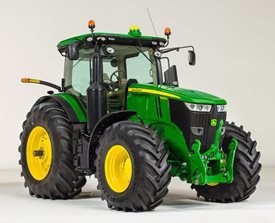 7R with TLS Plus
7R with TLS Plus
The optional TLS Plus is a fully integrated, self-leveling front suspension system available on 7R Tractors equipped with the 1300 mechanical front-wheel drive (MFWD) axle. TLS Plus provides exclusive front suspension using a hydro-pneumatic self-leveling system to increase productivity and improve ride dramatically. TLS Plus provides more control over the front suspension of the tractor.
TLS Plus increases both transport and field productivity with superior stability, ride, and comfort. Loader operators appreciate the enhanced performance when transporting bales or a full bucket of silage. In the field, the TLS Plus front suspension maintains ground-to-tire contact, enabling more power to the ground.
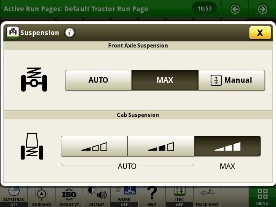 CommandCenter screen
CommandCenter screen
In the Generation 4 CommandCenter™ Display, the operator is able to select maximum pressure to accommodate for the transfer of heavy loads with minimal front axle movement.
The TLS Plus front axle is available with or without wet-disk front brakes. While TLS Plus is available on all 7R Tractors, it is a requirement for the following:
- 31 mph/50K e23™ transmission
- 31 mph/50K Infinitely Variable Transmission (IVT™)
John Deere Connected Support™ transforms the industry
 Maximizing uptime for John Deere customers through the use of connectivity and technology
Maximizing uptime for John Deere customers through the use of connectivity and technology
John Deere Connected Support is a proactive service approach that utilizes the telematics machine connection to leverage a suite of remote support tools available to improve service efficiency and reduce machine downtime on all 7, 8, and 9 Family Tractors.
- Proactive services that drive more uptime
- In-the-moment services to ensure quality job performance
- Leveraging technology to be more effective and efficient
You know that when you’re in the field the unexpected can happen. When it does, you need a quick resolution. That’s why John Deere equipment is prepared with technology that senses potential issues and can alert you promptly—in the cab or anywhere you are. Better yet, your dealer can receive alerts and connect to your equipment. You know your dealer is always ready to keep you farming – and farming better. Starting with model year 2020, your John Deere tractors will come with a 5-year JDLink™ subscription from the factory that makes this connection possible.
 John Deere Connected Support tools
John Deere Connected Support tools
Stop fearing the unexpected and start planning for it with the following John Deere Connected Support tools.
Gain the advantages of a JDLink™ connected machine
 Monitor machines on the go
Monitor machines on the go
 Connectivity provides data that drives better decisions
Connectivity provides data that drives better decisions
Customer needs and their success is John Deere’s focus. As functionality becomes more accepted and even expected, that functionality moves from being optional to being included with the machine. In model year 2019, AutoTrac™ guidance and documentation was included on machines equipped with a 4600 CommandCenter™ Display. Five years of JDLink is also included with the purchase of all model year 2020 machines equipped with a 4G LTE Modular Telematics Gateway (MTG). The functionality of JDLink on these machines includes everything that was previously included with JDLink Access + Remote Display Access (RDA) and JDLink Connect subscriptions. This added connectivity enables customers to more easily realize the value of a connected machine.
- Easily transfer data and collaborate with trusted advisors to plan your field work quickly. You or your employees can spend more time in the field working rather than sitting on a headland setting up the technology. With a connection between John Deere Operations Center and your machines, changes to field plans occur as needed. Those changes may include changes in varieties, application rates, or machines.
- Better enable data-driven decisions. By using the insights gathered from machines along with the tools in Operations Center (e.g., Field Analyzer, Field Analyzer Beta, and Machine Analyzer) you can understand how your fields are performing and what field plans had an impact. John Deere Operations Center gives you access to more than 100 connected software tools, so you have the ultimate choice of popular industry tools. And, if you don't want to analyze the data yourself, you can share the data with those that help you make decisions to provide the insights you need.
- Report work completed accurately and timely for compliance and billing purposes.
- Increase machine uptime with Connected Support. Your local John Deere dealer can provide remote monitoring services and diagnostics to help keep your machines up and running, reduce your maintenance expenses through early detection of problems, and provide over-the-air software updates for displays, receivers, and controllers.
- Get quick in-field support with RDA. You can monitor your machines from your office computer or a mobile device on the go.
- Remotely manage machines and employees to give you insights into how they are performing. If machines are being underutilized or field operations are not being properly conducted, you can put plans in place to improve productivity.
- Quickly make changes to improve your harvesting operations by remotely viewing and adjusting combine settings.
To use JDLink, the following is required:
- MTG
- An active JDLink subscription
- A John Deere Operations Center account to access machine and agronomic data
Take advantage of the Generation 4 CommandCenter™ display, designed for efficiency
The Generation 4 CommandCenter was designed to provide a consistent user experience by providing full-screen viewing of more run page modules, shortcut keys, and precision agriculture capabilities.
Expect easier set-up, along with increased operator confidence, thanks to a simple, customizable interface. The improved design of the Generation 4 CommandCenter also aids in an optimal operating experience and maximizes uptime.
In order to increase your efficiency, take advantage of the following features offered by the Generation 4 CommandCenter:
Layout manager
 Layout manager selection page
Layout manager selection page
 Layout manager module build
Layout manager module build
- Easily create page views that meet your needs and that are also equipped with default run pages.
- Users and access allow the owner or manager to lock out certain functions to prevent operators from accessing or changing settings with a defined four-digit code.
- Gather on-screen help by selecting the help icon on the shortcut bar on the bottom of every page.
Machine monitor
 Machine monitor page
Machine monitor page
- The Machine Monitor application provides you instantaneous readings about the status or condition of your machine.
- This application shows parameters such as engine speed, coolant temperature, and ground speed.
Work monitor
 Work monitor page
Work monitor page
- The Work Monitor application displays performance information about the task being performed by the machine.
- You are shown averages, totals, and productivity of the machine, such as area worked, average working speed, and fuel usage.
- Work setup places the settings needed to properly setup features such as AutoTrac, Documentation, and Section Control in a single location. Settings include:
- Client, farm, and field
- Crop type
- Machine and implement dimensions
- Variety/hybrid and planting/seeding rates
- Variable rate prescriptions
- Product and application rates
- Application rates through the implement screens
Video capability
- Machines equipped with a 4200 CommandCenter are equipped with one video input, and the 4600 CommandCenter has four video inputs.
- You have the ability to set a variety of triggers. With each trigger, the image will then appear on the display.
Flags
 Create flags to mark items in the field
Create flags to mark items in the field
- Mark areas in the field that need special attention such as rocks, tile lines, or weed pressure.
- Flags previously recorded on the Gen 4 or GreenStar™ 3 2630 Display can be transferred between monitors.
- Flags previously recorded on the Gen 4 or GreenStar™ 3 2630 Display can be transferred between monitors.
Field boundaries
 Boundary creation from coverage
Boundary creation from coverage
 Headland creation
Headland creation
- Manually drive field boundaries with the Generation 4 CommandCenter or import existing boundary information from the GreenStar 3 2630 Display or John Deere Operations Center. Gen 4 documentation data can be used to create boundaries from coverage within the John Deere Operations Center.
Dual-display mode
 Dual display
Dual display
- Generation 4 CommandCenter may be configured to run with the following John Deere displays connected at the cornerpost of a John Deere tractor:
- GreenStar 2 1800 Display
- GreenStar 2 2600 Display
- GreenStar 3 2630 Display
- 4640 Universal Display
- 4240 Universal Display
NOTE: Vehicle applications will always be located on the Gen 4 CommandCenter.
Automatic base station switching
 Setup base stations in Fields and Boundaries applications
Setup base stations in Fields and Boundaries applications
- Customers using John Deere RTK Radio 450 or 900 can link a base station to a desired client,/ farm,/ or field. This allows automatic switching to the associated base station when changing fields. The ability to import base station assignments into Operations Center and send back to machines will be available at a later date.
Video looping supported with Gen 4 4600 CommandCenter Display and 4640 Universal Display
 Scan through videos with video looping
Scan through videos with video looping
- This feature enables users to scan or loop through all of the available video feeds for a specified duration. The default scan time is set to 7 seconds per image. The scan time is customizable per image allowing for consistent visibility to all video feeds.
Maximize versatility with front hitch options that fit a variety of applications
 7 Family Tractor with front hitch
7 Family Tractor with front hitch
The 7 Family Tractors offer two front hitch options to best fit a variety of applications.
Standard (non-ground-engaging) hitch option for applications including, but not limited to:
- Front-mounted mowers, toppers, and snow blowers
- Carrying front seed hoppers and plow packers
- Carrying front ballast
- Operating light-draft implements
Premium (ground-engaging) hitch option for applications including, but not limited to:
- Operating primary tillage equipment and standard blades
Premium hitches include a push bar and heavier lift arms:
- Hitches with zero front auxiliary valves include one mid-mount valve.
- Hitches with one front auxiliary valve include two mid-mount valves.
- Hitches with two front auxiliary valves include three mid-mount valves.
To ensure adequate hydraulic availability, up to two selective control valves (SCVs) can be included with a front hitch.
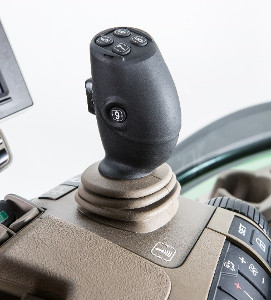 Joystick control
Joystick control
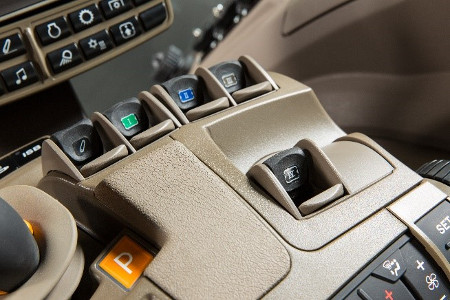 Paddle pot SCV
Paddle pot SCV
Tractors equipped with a factory front hitch have the option of selecting a joystick control or paddle pot SCV controls. The joystick control is not compatible with the sixth rear electrohydraulic SCV because of the CommandARM™ controls space required for the front hitch joystick.
Simple turnkey experience with the StarFire™ 6000 Integrated Receiver
 StarFire 6000 Integrated Receiver
StarFire 6000 Integrated Receiver
The John Deere StarFire™ 6000 Integrated Receiver is the new standard in John Deere Precision Ag technology. The integrated design further enhances the value that you have come to expect from StarFire products.
The StarFire 6000 Integrated Receiver eliminates all setup, installation, and calibrations. There is no need to verify machine and receiver measurements, as this has been done precisely for you at the factory. You will spend 60 minutes less per receiver move each season, which gives you more time to focus on other parts of your operation.
With updated Ethernet connectivity, software updates are easier and faster. StarFire 6000 Integrated Receiver maintains the speed to update software in under 4 minutes while remaining in the cab. Over-the-air updates are 85 percent faster with the StarFire 6000 Integrated Receiver because of Ethernet connectivity.
Features
Experience the ultimate in comfort with the Ultimate Comfort and Convenience package
 Ultimate Comfort and Convenience package
Ultimate Comfort and Convenience package
The Ultimate Comfort and Convenience package offers unsurpassed visibility, operator comfort, control placement, and ride and sound quality. Features in this package include:
Controls
- CommandARM™ console with hitch and hydraulic integrated controls
- Air conditioner and heater with automatic temperature controls
- Radio and volume controls
- Hitch control lever lock and selective control lever lock
- Tilt/telescoping steering wheel with position memory
- Auto trac resume button
- iTEC™ engagement buttons
Displays
- 21.3-cm (8.4-in.) 4200 or 26.4-cm (10.4-in.) 4600 Generation 4 CommandCenter™ Display
- Digital cornerpost display with:
- Fuel level gauge, including low fuel warning
- Temperature gauge
- Diesel exhaust fluid (DEF) gauge, including low DEF warning
- Engine rpm
- Transmission commanded gear or wheel speed
- Vehicle system functions, such as iTEC system, that are operating
- Monitor mounts on right-hand front post and rear cab post
Storage
- Storage compartment underneath the instructor seat
- Left-hand ceiling storage compartment
- Refrigerator located on the left side behind the instructor seat
- Beverage holders sized to accommodate various containers
Sound
- Passive noise reduction system
- Premium sound system, including touchscreen radio, smartphone interface, AM/FM/WX, aux and Bluetooth® with voice control, inputs, XM® ready, six speakers with one subwoofer, and business band ready
Outlets
- Three 12-V convenience outlet (cigarette lighter style)
- Six 12-V three-pin outlet with adapter (provides switched and unswitched power)
- Four charging USB ports
- 120-V AC power outlet
- One International Organization for Standardization (ISO) nine-pin connector
- Power strip with convenience plug adapter
- Service ADVISOR™ data port
Mirrors
- Inside-mounted rearview mirror
- Right and left outside mirrors (manually adjustable mirror head)
Windows
- Swing-out rear window that opens 30 degrees
- Laminated glass
- Two-speed and intermittent front, rear, and right-hand side wiper with washer
- Front, left and right-hand side, and rear pull-down sunshade
Lights
- Interior dome light in the ceiling
- Map lights
For additional attachments and mounting solutions, see Cab convenience or Cab mounting solutions.
Seat
 Leather seat
Leather seat
The seat improves ride quality and helps to reduce operator fatigue.
Features include:
- Leather
- Heat and ventilation to keep the operator at a comfortable temperature
- Adjustable bolsters
- Massage functionality
- Electronic controls to adjust to operator preference
- Pneumatic lumbar adjustment
- Seat height adjustments conveniently located below the left armrest
- Fore-aft adjustment is easy to reach, located below the left armrest
- Cushion length adjustment to get the perfect fit
- Swivel adjustment, located on the front of the seat, allows the seat to be swiveled 40 degrees to the right or 25 degrees to the left of the center position with a pivoting CommandARM console
- Seat can be configured with air seat suspension, ActiveSeat™ II suspension or air seat plus cab suspension
- Operator presence switch warns if the operator is out of the seat while operating key functions
- Seat belt retractor
- Centered cab seat provides excellent over-shoulder visibility
- Adjustable shock absorber permits ride adjustment from soft to firm to match the operator's desired comfort level
- Removable cushions allow for easy cleaning
- Folding instructional seat
Bluetooth is a trademark of Bluetooth SIG, Inc. XM is a trademark of Sirius XM Radio, Inc.
Get 360 degrees of coverage for maximum productivity with visibility packages
 Ultimate Visibility package
Ultimate Visibility package
Visibility is one of the most important attributes of the cab. While lighting is a large portion of that, features like windshield wipers, mirrors, sunshades, and cameras are also important to overall visibility. For this reason, John Deere offers three visibility packages on 7 and 8 Family Tractors:
- Select
- Premium
- Ultimate
Lighting
The lighting configurations are available to match various applications and ensure maximum around-the-clock productivity.
Light housings are large, allowing for optimum total lumens and available light. The Select Visibility package uses 65-W halogen bulbs, whereas the Premium and Ultimate Visibility packages use light-emitting diode (LED) lights. The Premium and Ultimate Visibility packages replace Select Visibility package’s halogen lights with LED lights. The only lights that are not LED are the low-beam driving lights; they remain halogen. This allows each LED light to work at a lower temperature and no one light works harder than any other. The uniformity in LED coverage allows only one type of light output surrounding the tractor.
The lighting pattern in the Ultimate Visibility package provides industry-leading performance in nighttime visibility. LED lights provide maximum brightness and a true color output for excellent field definition that is easy on the operator's eyes.
The LED lights provide 40 percent greater coverage width and 10 percent more light coverage in the rear. LED lighting packages use 45 percent less amps than standard halogen lights and have an increased life expectancy over HID lights which leads to lower costs of ownership over the life of the tractor.
The low- and high-beam driving/work lights are adjustable. Please refer to the electrical section in the Operator’s Manual for complete details on adjusting lights.
NOTE: Lighting packages may vary depending on region.
ActiveSeat™ II seat provides a smoother ride
 ActiveSeat II and controls
ActiveSeat II and controls
The John Deere Active Seat II utilizes an electrical control system to control the vertical seat top movement. The "active" control system minimizes vertical seat top acceleration by sensing vertical tractor inputs and actively positioning the seat top to cancel those inputs. This results in a significantly smoother ride for the operator.
The John Deere ActiveSeat II has many of the same features of the air suspension seat with the addition of a ride firmness switch. The ride firmness switch is located on the left-hand armrest and replaces the suspension shock-dampening seat attenuation lever on the front right-hand side of the seat controls.
The ride firmness switch has three positions: plus, minus, and mid position. The three positions provide three different levels of seat performance:
- The plus position provides the greatest degree of ride firmness. This position allows more of the tractor's inputs to be felt by the operator (slightly rougher ride).
- The minus position provides the least degree of ride firmness, allowing minimal tractor inputs to reach the operator, resulting in maximum seat performance.
- The mid position allows a balance between the plus (+) and minus (-) settings.
 ActiveSeat II left armrest controls
ActiveSeat II left armrest controls
The ActiveSeat II is also available as a heated and ventilated leather seat for increased comfort and easier cleaning. This is only available with the Ultimate Comfort and Convenience package. For tractor applications where operating speed is not limited by the implement, the ActiveSeat II can allow for faster field speeds and increased overall comfort and productivity.
The leather seat includes massaging capability to alleviate operator fatigue.
Right-hand seat swivel has been improved above current 8R Tractors to 25 degrees (versus 8 degrees) to the left and 40 degrees to the right in the Premium and Ultimate Comfort and Convenience packages.
NOTE: The John Deere ActiveSeat II is not available on track tractors.
Efficiency and comfort in the palm of your hand using CommandPRO™ control
 CommandARM™ console with CommandPRO control
CommandARM™ console with CommandPRO control
The unique driving strategy is designed to deliver highest performance in combination with operator comfort making the daily work much easier and efficient.
Driving strategy
- Pedal and joystick mode are active at the same time
- ActiveZero keeps the output speed actively at 0 km/h (0 mph) until command for acceleration is given independent of load or engine speed
- Command top and zero speed simply by one push or pull
- Unique inching control
- Three easily adjustable travel set speeds
- Two engine set speeds
- Three acceleration response settings
 Driving strategy
Driving strategy
| Forward movement | Reverse movement | |
| 1 | Accelerate | Decelerate |
| 2 | Top set speed | Zero speed |
| 3 | Decelerate | Accelerate |
| 4 | Zero speed | Accelerate |
| 5 | Activate set speed | |
| 6 | Select direction | |
| 7 | Inching speed | |
| 8 | Inching speed | |
NOTE: The CommandPro control is only available on IVT transmissions.
Increase productivity with Triple-Link Suspension Plus (TLS™ Plus)
 7R with TLS Plus
7R with TLS Plus
The optional TLS Plus is a fully integrated, self-leveling front suspension system available on 7R Tractors equipped with the 1300 mechanical front-wheel drive (MFWD) axle. TLS Plus provides exclusive front suspension using a hydro-pneumatic self-leveling system to increase productivity and improve ride dramatically. TLS Plus provides more control over the front suspension of the tractor.
TLS Plus increases both transport and field productivity with superior stability, ride, and comfort. Loader operators appreciate the enhanced performance when transporting bales or a full bucket of silage. In the field, the TLS Plus front suspension maintains ground-to-tire contact, enabling more power to the ground.
 CommandCenter screen
CommandCenter screen
In the Generation 4 CommandCenter™ Display, the operator is able to select maximum pressure to accommodate for the transfer of heavy loads with minimal front axle movement.
The TLS Plus front axle is available with or without wet-disk front brakes. While TLS Plus is available on all 7R Tractors, it is a requirement for the following:
- 31 mph/50K e23™ transmission
- 31 mph/50K Infinitely Variable Transmission (IVT™)
John Deere Connected Support™ transforms the industry
 Maximizing uptime for John Deere customers through the use of connectivity and technology
Maximizing uptime for John Deere customers through the use of connectivity and technology
John Deere Connected Support is a proactive service approach that utilizes the telematics machine connection to leverage a suite of remote support tools available to improve service efficiency and reduce machine downtime on all 7, 8, and 9 Family Tractors.
- Proactive services that drive more uptime
- In-the-moment services to ensure quality job performance
- Leveraging technology to be more effective and efficient
You know that when you’re in the field the unexpected can happen. When it does, you need a quick resolution. That’s why John Deere equipment is prepared with technology that senses potential issues and can alert you promptly—in the cab or anywhere you are. Better yet, your dealer can receive alerts and connect to your equipment. You know your dealer is always ready to keep you farming – and farming better. Starting with model year 2020, your John Deere tractors will come with a 5-year JDLink™ subscription from the factory that makes this connection possible.
 John Deere Connected Support tools
John Deere Connected Support tools
Stop fearing the unexpected and start planning for it with the following John Deere Connected Support tools.
Gain the advantages of a JDLink™ connected machine
 Monitor machines on the go
Monitor machines on the go
 Connectivity provides data that drives better decisions
Connectivity provides data that drives better decisions
Customer needs and their success is John Deere’s focus. As functionality becomes more accepted and even expected, that functionality moves from being optional to being included with the machine. In model year 2019, AutoTrac™ guidance and documentation was included on machines equipped with a 4600 CommandCenter™ Display. Five years of JDLink is also included with the purchase of all model year 2020 machines equipped with a 4G LTE Modular Telematics Gateway (MTG). The functionality of JDLink on these machines includes everything that was previously included with JDLink Access + Remote Display Access (RDA) and JDLink Connect subscriptions. This added connectivity enables customers to more easily realize the value of a connected machine.
- Easily transfer data and collaborate with trusted advisors to plan your field work quickly. You or your employees can spend more time in the field working rather than sitting on a headland setting up the technology. With a connection between John Deere Operations Center and your machines, changes to field plans occur as needed. Those changes may include changes in varieties, application rates, or machines.
- Better enable data-driven decisions. By using the insights gathered from machines along with the tools in Operations Center (e.g., Field Analyzer, Field Analyzer Beta, and Machine Analyzer) you can understand how your fields are performing and what field plans had an impact. John Deere Operations Center gives you access to more than 100 connected software tools, so you have the ultimate choice of popular industry tools. And, if you don't want to analyze the data yourself, you can share the data with those that help you make decisions to provide the insights you need.
- Report work completed accurately and timely for compliance and billing purposes.
- Increase machine uptime with Connected Support. Your local John Deere dealer can provide remote monitoring services and diagnostics to help keep your machines up and running, reduce your maintenance expenses through early detection of problems, and provide over-the-air software updates for displays, receivers, and controllers.
- Get quick in-field support with RDA. You can monitor your machines from your office computer or a mobile device on the go.
- Remotely manage machines and employees to give you insights into how they are performing. If machines are being underutilized or field operations are not being properly conducted, you can put plans in place to improve productivity.
- Quickly make changes to improve your harvesting operations by remotely viewing and adjusting combine settings.
To use JDLink, the following is required:
- MTG
- An active JDLink subscription
- A John Deere Operations Center account to access machine and agronomic data
Take advantage of the Generation 4 CommandCenter™ display, designed for efficiency
The Generation 4 CommandCenter was designed to provide a consistent user experience by providing full-screen viewing of more run page modules, shortcut keys, and precision agriculture capabilities.
Expect easier set-up, along with increased operator confidence, thanks to a simple, customizable interface. The improved design of the Generation 4 CommandCenter also aids in an optimal operating experience and maximizes uptime.
In order to increase your efficiency, take advantage of the following features offered by the Generation 4 CommandCenter:
Layout manager
 Layout manager selection page
Layout manager selection page
 Layout manager module build
Layout manager module build
- Easily create page views that meet your needs and that are also equipped with default run pages.
- Users and access allow the owner or manager to lock out certain functions to prevent operators from accessing or changing settings with a defined four-digit code.
- Gather on-screen help by selecting the help icon on the shortcut bar on the bottom of every page.
Machine monitor
 Machine monitor page
Machine monitor page
- The Machine Monitor application provides you instantaneous readings about the status or condition of your machine.
- This application shows parameters such as engine speed, coolant temperature, and ground speed.
Work monitor
 Work monitor page
Work monitor page
- The Work Monitor application displays performance information about the task being performed by the machine.
- You are shown averages, totals, and productivity of the machine, such as area worked, average working speed, and fuel usage.
- Work setup places the settings needed to properly setup features such as AutoTrac, Documentation, and Section Control in a single location. Settings include:
- Client, farm, and field
- Crop type
- Machine and implement dimensions
- Variety/hybrid and planting/seeding rates
- Variable rate prescriptions
- Product and application rates
- Application rates through the implement screens
Video capability
- Machines equipped with a 4200 CommandCenter are equipped with one video input, and the 4600 CommandCenter has four video inputs.
- You have the ability to set a variety of triggers. With each trigger, the image will then appear on the display.
Flags
 Create flags to mark items in the field
Create flags to mark items in the field
- Mark areas in the field that need special attention such as rocks, tile lines, or weed pressure.
- Flags previously recorded on the Gen 4 or GreenStar™ 3 2630 Display can be transferred between monitors.
- Flags previously recorded on the Gen 4 or GreenStar™ 3 2630 Display can be transferred between monitors.
Field boundaries
 Boundary creation from coverage
Boundary creation from coverage
 Headland creation
Headland creation
- Manually drive field boundaries with the Generation 4 CommandCenter or import existing boundary information from the GreenStar 3 2630 Display or John Deere Operations Center. Gen 4 documentation data can be used to create boundaries from coverage within the John Deere Operations Center.
Dual-display mode
 Dual display
Dual display
- Generation 4 CommandCenter may be configured to run with the following John Deere displays connected at the cornerpost of a John Deere tractor:
- GreenStar 2 1800 Display
- GreenStar 2 2600 Display
- GreenStar 3 2630 Display
- 4640 Universal Display
- 4240 Universal Display
NOTE: Vehicle applications will always be located on the Gen 4 CommandCenter.
Automatic base station switching
 Setup base stations in Fields and Boundaries applications
Setup base stations in Fields and Boundaries applications
- Customers using John Deere RTK Radio 450 or 900 can link a base station to a desired client,/ farm,/ or field. This allows automatic switching to the associated base station when changing fields. The ability to import base station assignments into Operations Center and send back to machines will be available at a later date.
Video looping supported with Gen 4 4600 CommandCenter Display and 4640 Universal Display
 Scan through videos with video looping
Scan through videos with video looping
- This feature enables users to scan or loop through all of the available video feeds for a specified duration. The default scan time is set to 7 seconds per image. The scan time is customizable per image allowing for consistent visibility to all video feeds.
Maximize versatility with front hitch options that fit a variety of applications
 7 Family Tractor with front hitch
7 Family Tractor with front hitch
The 7 Family Tractors offer two front hitch options to best fit a variety of applications.
Standard (non-ground-engaging) hitch option for applications including, but not limited to:
- Front-mounted mowers, toppers, and snow blowers
- Carrying front seed hoppers and plow packers
- Carrying front ballast
- Operating light-draft implements
Premium (ground-engaging) hitch option for applications including, but not limited to:
- Operating primary tillage equipment and standard blades
Premium hitches include a push bar and heavier lift arms:
- Hitches with zero front auxiliary valves include one mid-mount valve.
- Hitches with one front auxiliary valve include two mid-mount valves.
- Hitches with two front auxiliary valves include three mid-mount valves.
To ensure adequate hydraulic availability, up to two selective control valves (SCVs) can be included with a front hitch.
 Joystick control
Joystick control
 Paddle pot SCV
Paddle pot SCV
Tractors equipped with a factory front hitch have the option of selecting a joystick control or paddle pot SCV controls. The joystick control is not compatible with the sixth rear electrohydraulic SCV because of the CommandARM™ controls space required for the front hitch joystick.
Simple turnkey experience with the StarFire™ 6000 Integrated Receiver
 StarFire 6000 Integrated Receiver
StarFire 6000 Integrated Receiver
The John Deere StarFire™ 6000 Integrated Receiver is the new standard in John Deere Precision Ag technology. The integrated design further enhances the value that you have come to expect from StarFire products.
The StarFire 6000 Integrated Receiver eliminates all setup, installation, and calibrations. There is no need to verify machine and receiver measurements, as this has been done precisely for you at the factory. You will spend 60 minutes less per receiver move each season, which gives you more time to focus on other parts of your operation.
With updated Ethernet connectivity, software updates are easier and faster. StarFire 6000 Integrated Receiver maintains the speed to update software in under 4 minutes while remaining in the cab. Over-the-air updates are 85 percent faster with the StarFire 6000 Integrated Receiver because of Ethernet connectivity.
Features
Experience the ultimate in comfort with the Ultimate Comfort and Convenience package
 Ultimate Comfort and Convenience package
Ultimate Comfort and Convenience package
The Ultimate Comfort and Convenience package offers unsurpassed visibility, operator comfort, control placement, and ride and sound quality. Features in this package include:
Controls
- CommandARM™ console with hitch and hydraulic integrated controls
- Air conditioner and heater with automatic temperature controls
- Radio and volume controls
- Hitch control lever lock and selective control lever lock
- Tilt/telescoping steering wheel with position memory
- Auto trac resume button
- iTEC™ engagement buttons
Displays
- 21.3-cm (8.4-in.) 4200 or 26.4-cm (10.4-in.) 4600 Generation 4 CommandCenter™ Display
- Digital cornerpost display with:
- Fuel level gauge, including low fuel warning
- Temperature gauge
- Diesel exhaust fluid (DEF) gauge, including low DEF warning
- Engine rpm
- Transmission commanded gear or wheel speed
- Vehicle system functions, such as iTEC system, that are operating
- Monitor mounts on right-hand front post and rear cab post
Storage
- Storage compartment underneath the instructor seat
- Left-hand ceiling storage compartment
- Refrigerator located on the left side behind the instructor seat
- Beverage holders sized to accommodate various containers
Sound
- Passive noise reduction system
- Premium sound system, including touchscreen radio, smartphone interface, AM/FM/WX, aux and Bluetooth® with voice control, inputs, XM® ready, six speakers with one subwoofer, and business band ready
Outlets
- Three 12-V convenience outlet (cigarette lighter style)
- Six 12-V three-pin outlet with adapter (provides switched and unswitched power)
- Four charging USB ports
- 120-V AC power outlet
- One International Organization for Standardization (ISO) nine-pin connector
- Power strip with convenience plug adapter
- Service ADVISOR™ data port
Mirrors
- Inside-mounted rearview mirror
- Right and left outside mirrors (manually adjustable mirror head)
Windows
- Swing-out rear window that opens 30 degrees
- Laminated glass
- Two-speed and intermittent front, rear, and right-hand side wiper with washer
- Front, left and right-hand side, and rear pull-down sunshade
Lights
- Interior dome light in the ceiling
- Map lights
For additional attachments and mounting solutions, see Cab convenience or Cab mounting solutions.
Seat
 Leather seat
Leather seat
The seat improves ride quality and helps to reduce operator fatigue.
Features include:
- Leather
- Heat and ventilation to keep the operator at a comfortable temperature
- Adjustable bolsters
- Massage functionality
- Electronic controls to adjust to operator preference
- Pneumatic lumbar adjustment
- Seat height adjustments conveniently located below the left armrest
- Fore-aft adjustment is easy to reach, located below the left armrest
- Cushion length adjustment to get the perfect fit
- Swivel adjustment, located on the front of the seat, allows the seat to be swiveled 40 degrees to the right or 25 degrees to the left of the center position with a pivoting CommandARM console
- Seat can be configured with air seat suspension, ActiveSeat™ II suspension or air seat plus cab suspension
- Operator presence switch warns if the operator is out of the seat while operating key functions
- Seat belt retractor
- Centered cab seat provides excellent over-shoulder visibility
- Adjustable shock absorber permits ride adjustment from soft to firm to match the operator's desired comfort level
- Removable cushions allow for easy cleaning
- Folding instructional seat
Bluetooth is a trademark of Bluetooth SIG, Inc. XM is a trademark of Sirius XM Radio, Inc.
Get 360 degrees of coverage for maximum productivity with visibility packages
 Ultimate Visibility package
Ultimate Visibility package
Visibility is one of the most important attributes of the cab. While lighting is a large portion of that, features like windshield wipers, mirrors, sunshades, and cameras are also important to overall visibility. For this reason, John Deere offers three visibility packages on 7 and 8 Family Tractors:
- Select
- Premium
- Ultimate
Lighting
The lighting configurations are available to match various applications and ensure maximum around-the-clock productivity.
Light housings are large, allowing for optimum total lumens and available light. The Select Visibility package uses 65-W halogen bulbs, whereas the Premium and Ultimate Visibility packages use light-emitting diode (LED) lights. The Premium and Ultimate Visibility packages replace Select Visibility package’s halogen lights with LED lights. The only lights that are not LED are the low-beam driving lights; they remain halogen. This allows each LED light to work at a lower temperature and no one light works harder than any other. The uniformity in LED coverage allows only one type of light output surrounding the tractor.
The lighting pattern in the Ultimate Visibility package provides industry-leading performance in nighttime visibility. LED lights provide maximum brightness and a true color output for excellent field definition that is easy on the operator's eyes.
The LED lights provide 40 percent greater coverage width and 10 percent more light coverage in the rear. LED lighting packages use 45 percent less amps than standard halogen lights and have an increased life expectancy over HID lights which leads to lower costs of ownership over the life of the tractor.
The low- and high-beam driving/work lights are adjustable. Please refer to the electrical section in the Operator’s Manual for complete details on adjusting lights.
NOTE: Lighting packages may vary depending on region.
ActiveSeat™ II seat provides a smoother ride
 ActiveSeat II and controls
ActiveSeat II and controls
The John Deere Active Seat II utilizes an electrical control system to control the vertical seat top movement. The "active" control system minimizes vertical seat top acceleration by sensing vertical tractor inputs and actively positioning the seat top to cancel those inputs. This results in a significantly smoother ride for the operator.
The John Deere ActiveSeat II has many of the same features of the air suspension seat with the addition of a ride firmness switch. The ride firmness switch is located on the left-hand armrest and replaces the suspension shock-dampening seat attenuation lever on the front right-hand side of the seat controls.
The ride firmness switch has three positions: plus, minus, and mid position. The three positions provide three different levels of seat performance:
- The plus position provides the greatest degree of ride firmness. This position allows more of the tractor's inputs to be felt by the operator (slightly rougher ride).
- The minus position provides the least degree of ride firmness, allowing minimal tractor inputs to reach the operator, resulting in maximum seat performance.
- The mid position allows a balance between the plus (+) and minus (-) settings.
 ActiveSeat II left armrest controls
ActiveSeat II left armrest controls
The ActiveSeat II is also available as a heated and ventilated leather seat for increased comfort and easier cleaning. This is only available with the Ultimate Comfort and Convenience package. For tractor applications where operating speed is not limited by the implement, the ActiveSeat II can allow for faster field speeds and increased overall comfort and productivity.
The leather seat includes massaging capability to alleviate operator fatigue.
Right-hand seat swivel has been improved above current 8R Tractors to 25 degrees (versus 8 degrees) to the left and 40 degrees to the right in the Premium and Ultimate Comfort and Convenience packages.
NOTE: The John Deere ActiveSeat II is not available on track tractors.
Efficiency and comfort in the palm of your hand using CommandPRO™ control
 CommandARM™ console with CommandPRO control
CommandARM™ console with CommandPRO control
The unique driving strategy is designed to deliver highest performance in combination with operator comfort making the daily work much easier and efficient.
Driving strategy
- Pedal and joystick mode are active at the same time
- ActiveZero keeps the output speed actively at 0 km/h (0 mph) until command for acceleration is given independent of load or engine speed
- Command top and zero speed simply by one push or pull
- Unique inching control
- Three easily adjustable travel set speeds
- Two engine set speeds
- Three acceleration response settings
 Driving strategy
Driving strategy
| Forward movement | Reverse movement | |
| 1 | Accelerate | Decelerate |
| 2 | Top set speed | Zero speed |
| 3 | Decelerate | Accelerate |
| 4 | Zero speed | Accelerate |
| 5 | Activate set speed | |
| 6 | Select direction | |
| 7 | Inching speed | |
| 8 | Inching speed | |
NOTE: The CommandPro control is only available on IVT transmissions.
Increase productivity with Triple-Link Suspension Plus (TLS™ Plus)
 7R with TLS Plus
7R with TLS Plus
The optional TLS Plus is a fully integrated, self-leveling front suspension system available on 7R Tractors equipped with the 1300 mechanical front-wheel drive (MFWD) axle. TLS Plus provides exclusive front suspension using a hydro-pneumatic self-leveling system to increase productivity and improve ride dramatically. TLS Plus provides more control over the front suspension of the tractor.
TLS Plus increases both transport and field productivity with superior stability, ride, and comfort. Loader operators appreciate the enhanced performance when transporting bales or a full bucket of silage. In the field, the TLS Plus front suspension maintains ground-to-tire contact, enabling more power to the ground.
 CommandCenter screen
CommandCenter screen
In the Generation 4 CommandCenter™ Display, the operator is able to select maximum pressure to accommodate for the transfer of heavy loads with minimal front axle movement.
The TLS Plus front axle is available with or without wet-disk front brakes. While TLS Plus is available on all 7R Tractors, it is a requirement for the following:
- 31 mph/50K e23™ transmission
- 31 mph/50K Infinitely Variable Transmission (IVT™)
John Deere Connected Support™ transforms the industry
 Maximizing uptime for John Deere customers through the use of connectivity and technology
Maximizing uptime for John Deere customers through the use of connectivity and technology
John Deere Connected Support is a proactive service approach that utilizes the telematics machine connection to leverage a suite of remote support tools available to improve service efficiency and reduce machine downtime on all 7, 8, and 9 Family Tractors.
- Proactive services that drive more uptime
- In-the-moment services to ensure quality job performance
- Leveraging technology to be more effective and efficient
You know that when you’re in the field the unexpected can happen. When it does, you need a quick resolution. That’s why John Deere equipment is prepared with technology that senses potential issues and can alert you promptly—in the cab or anywhere you are. Better yet, your dealer can receive alerts and connect to your equipment. You know your dealer is always ready to keep you farming – and farming better. Starting with model year 2020, your John Deere tractors will come with a 5-year JDLink™ subscription from the factory that makes this connection possible.
 John Deere Connected Support tools
John Deere Connected Support tools
Stop fearing the unexpected and start planning for it with the following John Deere Connected Support tools.
Gain the advantages of a JDLink™ connected machine
 Monitor machines on the go
Monitor machines on the go
 Connectivity provides data that drives better decisions
Connectivity provides data that drives better decisions
Customer needs and their success is John Deere’s focus. As functionality becomes more accepted and even expected, that functionality moves from being optional to being included with the machine. In model year 2019, AutoTrac™ guidance and documentation was included on machines equipped with a 4600 CommandCenter™ Display. Five years of JDLink is also included with the purchase of all model year 2020 machines equipped with a 4G LTE Modular Telematics Gateway (MTG). The functionality of JDLink on these machines includes everything that was previously included with JDLink Access + Remote Display Access (RDA) and JDLink Connect subscriptions. This added connectivity enables customers to more easily realize the value of a connected machine.
- Easily transfer data and collaborate with trusted advisors to plan your field work quickly. You or your employees can spend more time in the field working rather than sitting on a headland setting up the technology. With a connection between John Deere Operations Center and your machines, changes to field plans occur as needed. Those changes may include changes in varieties, application rates, or machines.
- Better enable data-driven decisions. By using the insights gathered from machines along with the tools in Operations Center (e.g., Field Analyzer, Field Analyzer Beta, and Machine Analyzer) you can understand how your fields are performing and what field plans had an impact. John Deere Operations Center gives you access to more than 100 connected software tools, so you have the ultimate choice of popular industry tools. And, if you don't want to analyze the data yourself, you can share the data with those that help you make decisions to provide the insights you need.
- Report work completed accurately and timely for compliance and billing purposes.
- Increase machine uptime with Connected Support. Your local John Deere dealer can provide remote monitoring services and diagnostics to help keep your machines up and running, reduce your maintenance expenses through early detection of problems, and provide over-the-air software updates for displays, receivers, and controllers.
- Get quick in-field support with RDA. You can monitor your machines from your office computer or a mobile device on the go.
- Remotely manage machines and employees to give you insights into how they are performing. If machines are being underutilized or field operations are not being properly conducted, you can put plans in place to improve productivity.
- Quickly make changes to improve your harvesting operations by remotely viewing and adjusting combine settings.
To use JDLink, the following is required:
- MTG
- An active JDLink subscription
- A John Deere Operations Center account to access machine and agronomic data
Take advantage of the Generation 4 CommandCenter™ display, designed for efficiency
The Generation 4 CommandCenter was designed to provide a consistent user experience by providing full-screen viewing of more run page modules, shortcut keys, and precision agriculture capabilities.
Expect easier set-up, along with increased operator confidence, thanks to a simple, customizable interface. The improved design of the Generation 4 CommandCenter also aids in an optimal operating experience and maximizes uptime.
In order to increase your efficiency, take advantage of the following features offered by the Generation 4 CommandCenter:
Layout manager
 Layout manager selection page
Layout manager selection page
 Layout manager module build
Layout manager module build
- Easily create page views that meet your needs and that are also equipped with default run pages.
- Users and access allow the owner or manager to lock out certain functions to prevent operators from accessing or changing settings with a defined four-digit code.
- Gather on-screen help by selecting the help icon on the shortcut bar on the bottom of every page.
Machine monitor
 Machine monitor page
Machine monitor page
- The Machine Monitor application provides you instantaneous readings about the status or condition of your machine.
- This application shows parameters such as engine speed, coolant temperature, and ground speed.
Work monitor
 Work monitor page
Work monitor page
- The Work Monitor application displays performance information about the task being performed by the machine.
- You are shown averages, totals, and productivity of the machine, such as area worked, average working speed, and fuel usage.
- Work setup places the settings needed to properly setup features such as AutoTrac, Documentation, and Section Control in a single location. Settings include:
- Client, farm, and field
- Crop type
- Machine and implement dimensions
- Variety/hybrid and planting/seeding rates
- Variable rate prescriptions
- Product and application rates
- Application rates through the implement screens
Video capability
- Machines equipped with a 4200 CommandCenter are equipped with one video input, and the 4600 CommandCenter has four video inputs.
- You have the ability to set a variety of triggers. With each trigger, the image will then appear on the display.
Flags
 Create flags to mark items in the field
Create flags to mark items in the field
- Mark areas in the field that need special attention such as rocks, tile lines, or weed pressure.
- Flags previously recorded on the Gen 4 or GreenStar™ 3 2630 Display can be transferred between monitors.
- Flags previously recorded on the Gen 4 or GreenStar™ 3 2630 Display can be transferred between monitors.
Field boundaries
 Boundary creation from coverage
Boundary creation from coverage
 Headland creation
Headland creation
- Manually drive field boundaries with the Generation 4 CommandCenter or import existing boundary information from the GreenStar 3 2630 Display or John Deere Operations Center. Gen 4 documentation data can be used to create boundaries from coverage within the John Deere Operations Center.
Dual-display mode
 Dual display
Dual display
- Generation 4 CommandCenter may be configured to run with the following John Deere displays connected at the cornerpost of a John Deere tractor:
- GreenStar 2 1800 Display
- GreenStar 2 2600 Display
- GreenStar 3 2630 Display
- 4640 Universal Display
- 4240 Universal Display
NOTE: Vehicle applications will always be located on the Gen 4 CommandCenter.
Automatic base station switching
 Setup base stations in Fields and Boundaries applications
Setup base stations in Fields and Boundaries applications
- Customers using John Deere RTK Radio 450 or 900 can link a base station to a desired client,/ farm,/ or field. This allows automatic switching to the associated base station when changing fields. The ability to import base station assignments into Operations Center and send back to machines will be available at a later date.
Video looping supported with Gen 4 4600 CommandCenter Display and 4640 Universal Display
 Scan through videos with video looping
Scan through videos with video looping
- This feature enables users to scan or loop through all of the available video feeds for a specified duration. The default scan time is set to 7 seconds per image. The scan time is customizable per image allowing for consistent visibility to all video feeds.
Maximize versatility with front hitch options that fit a variety of applications
 7 Family Tractor with front hitch
7 Family Tractor with front hitch
The 7 Family Tractors offer two front hitch options to best fit a variety of applications.
Standard (non-ground-engaging) hitch option for applications including, but not limited to:
- Front-mounted mowers, toppers, and snow blowers
- Carrying front seed hoppers and plow packers
- Carrying front ballast
- Operating light-draft implements
Premium (ground-engaging) hitch option for applications including, but not limited to:
- Operating primary tillage equipment and standard blades
Premium hitches include a push bar and heavier lift arms:
- Hitches with zero front auxiliary valves include one mid-mount valve.
- Hitches with one front auxiliary valve include two mid-mount valves.
- Hitches with two front auxiliary valves include three mid-mount valves.
To ensure adequate hydraulic availability, up to two selective control valves (SCVs) can be included with a front hitch.
 Joystick control
Joystick control
 Paddle pot SCV
Paddle pot SCV
Tractors equipped with a factory front hitch have the option of selecting a joystick control or paddle pot SCV controls. The joystick control is not compatible with the sixth rear electrohydraulic SCV because of the CommandARM™ controls space required for the front hitch joystick.
Simple turnkey experience with the StarFire™ 6000 Integrated Receiver
 StarFire 6000 Integrated Receiver
StarFire 6000 Integrated Receiver
The John Deere StarFire™ 6000 Integrated Receiver is the new standard in John Deere Precision Ag technology. The integrated design further enhances the value that you have come to expect from StarFire products.
The StarFire 6000 Integrated Receiver eliminates all setup, installation, and calibrations. There is no need to verify machine and receiver measurements, as this has been done precisely for you at the factory. You will spend 60 minutes less per receiver move each season, which gives you more time to focus on other parts of your operation.
With updated Ethernet connectivity, software updates are easier and faster. StarFire 6000 Integrated Receiver maintains the speed to update software in under 4 minutes while remaining in the cab. Over-the-air updates are 85 percent faster with the StarFire 6000 Integrated Receiver because of Ethernet connectivity.
Features
Experience the ultimate in comfort with the Ultimate Comfort and Convenience package
 Ultimate Comfort and Convenience package
Ultimate Comfort and Convenience package
The Ultimate Comfort and Convenience package offers unsurpassed visibility, operator comfort, control placement, and ride and sound quality. Features in this package include:
Controls
- CommandARM™ console with hitch and hydraulic integrated controls
- Air conditioner and heater with automatic temperature controls
- Radio and volume controls
- Hitch control lever lock and selective control lever lock
- Tilt/telescoping steering wheel with position memory
- Auto trac resume button
- iTEC™ engagement buttons
Displays
- 21.3-cm (8.4-in.) 4200 or 26.4-cm (10.4-in.) 4600 Generation 4 CommandCenter™ Display
- Digital cornerpost display with:
- Fuel level gauge, including low fuel warning
- Temperature gauge
- Diesel exhaust fluid (DEF) gauge, including low DEF warning
- Engine rpm
- Transmission commanded gear or wheel speed
- Vehicle system functions, such as iTEC system, that are operating
- Monitor mounts on right-hand front post and rear cab post
Storage
- Storage compartment underneath the instructor seat
- Left-hand ceiling storage compartment
- Refrigerator located on the left side behind the instructor seat
- Beverage holders sized to accommodate various containers
Sound
- Passive noise reduction system
- Premium sound system, including touchscreen radio, smartphone interface, AM/FM/WX, aux and Bluetooth® with voice control, inputs, XM® ready, six speakers with one subwoofer, and business band ready
Outlets
- Three 12-V convenience outlet (cigarette lighter style)
- Six 12-V three-pin outlet with adapter (provides switched and unswitched power)
- Four charging USB ports
- 120-V AC power outlet
- One International Organization for Standardization (ISO) nine-pin connector
- Power strip with convenience plug adapter
- Service ADVISOR™ data port
Mirrors
- Inside-mounted rearview mirror
- Right and left outside mirrors (manually adjustable mirror head)
Windows
- Swing-out rear window that opens 30 degrees
- Laminated glass
- Two-speed and intermittent front, rear, and right-hand side wiper with washer
- Front, left and right-hand side, and rear pull-down sunshade
Lights
- Interior dome light in the ceiling
- Map lights
For additional attachments and mounting solutions, see Cab convenience or Cab mounting solutions.
Seat
 Leather seat
Leather seat
The seat improves ride quality and helps to reduce operator fatigue.
Features include:
- Leather
- Heat and ventilation to keep the operator at a comfortable temperature
- Adjustable bolsters
- Massage functionality
- Electronic controls to adjust to operator preference
- Pneumatic lumbar adjustment
- Seat height adjustments conveniently located below the left armrest
- Fore-aft adjustment is easy to reach, located below the left armrest
- Cushion length adjustment to get the perfect fit
- Swivel adjustment, located on the front of the seat, allows the seat to be swiveled 40 degrees to the right or 25 degrees to the left of the center position with a pivoting CommandARM console
- Seat can be configured with air seat suspension, ActiveSeat™ II suspension or air seat plus cab suspension
- Operator presence switch warns if the operator is out of the seat while operating key functions
- Seat belt retractor
- Centered cab seat provides excellent over-shoulder visibility
- Adjustable shock absorber permits ride adjustment from soft to firm to match the operator's desired comfort level
- Removable cushions allow for easy cleaning
- Folding instructional seat
Bluetooth is a trademark of Bluetooth SIG, Inc. XM is a trademark of Sirius XM Radio, Inc.
Get 360 degrees of coverage for maximum productivity with visibility packages
 Ultimate Visibility package
Ultimate Visibility package
Visibility is one of the most important attributes of the cab. While lighting is a large portion of that, features like windshield wipers, mirrors, sunshades, and cameras are also important to overall visibility. For this reason, John Deere offers three visibility packages on 7 and 8 Family Tractors:
- Select
- Premium
- Ultimate
Lighting
The lighting configurations are available to match various applications and ensure maximum around-the-clock productivity.
Light housings are large, allowing for optimum total lumens and available light. The Select Visibility package uses 65-W halogen bulbs, whereas the Premium and Ultimate Visibility packages use light-emitting diode (LED) lights. The Premium and Ultimate Visibility packages replace Select Visibility package’s halogen lights with LED lights. The only lights that are not LED are the low-beam driving lights; they remain halogen. This allows each LED light to work at a lower temperature and no one light works harder than any other. The uniformity in LED coverage allows only one type of light output surrounding the tractor.
The lighting pattern in the Ultimate Visibility package provides industry-leading performance in nighttime visibility. LED lights provide maximum brightness and a true color output for excellent field definition that is easy on the operator's eyes.
The LED lights provide 40 percent greater coverage width and 10 percent more light coverage in the rear. LED lighting packages use 45 percent less amps than standard halogen lights and have an increased life expectancy over HID lights which leads to lower costs of ownership over the life of the tractor.
The low- and high-beam driving/work lights are adjustable. Please refer to the electrical section in the Operator’s Manual for complete details on adjusting lights.
NOTE: Lighting packages may vary depending on region.
ActiveSeat™ II seat provides a smoother ride
 ActiveSeat II and controls
ActiveSeat II and controls
The John Deere Active Seat II utilizes an electrical control system to control the vertical seat top movement. The "active" control system minimizes vertical seat top acceleration by sensing vertical tractor inputs and actively positioning the seat top to cancel those inputs. This results in a significantly smoother ride for the operator.
The John Deere ActiveSeat II has many of the same features of the air suspension seat with the addition of a ride firmness switch. The ride firmness switch is located on the left-hand armrest and replaces the suspension shock-dampening seat attenuation lever on the front right-hand side of the seat controls.
The ride firmness switch has three positions: plus, minus, and mid position. The three positions provide three different levels of seat performance:
- The plus position provides the greatest degree of ride firmness. This position allows more of the tractor's inputs to be felt by the operator (slightly rougher ride).
- The minus position provides the least degree of ride firmness, allowing minimal tractor inputs to reach the operator, resulting in maximum seat performance.
- The mid position allows a balance between the plus (+) and minus (-) settings.
 ActiveSeat II left armrest controls
ActiveSeat II left armrest controls
The ActiveSeat II is also available as a heated and ventilated leather seat for increased comfort and easier cleaning. This is only available with the Ultimate Comfort and Convenience package. For tractor applications where operating speed is not limited by the implement, the ActiveSeat II can allow for faster field speeds and increased overall comfort and productivity.
The leather seat includes massaging capability to alleviate operator fatigue.
Right-hand seat swivel has been improved above current 8R Tractors to 25 degrees (versus 8 degrees) to the left and 40 degrees to the right in the Premium and Ultimate Comfort and Convenience packages.
NOTE: The John Deere ActiveSeat II is not available on track tractors.
Efficiency and comfort in the palm of your hand using CommandPRO™ control
 CommandARM™ console with CommandPRO control
CommandARM™ console with CommandPRO control
The unique driving strategy is designed to deliver highest performance in combination with operator comfort making the daily work much easier and efficient.
Driving strategy
- Pedal and joystick mode are active at the same time
- ActiveZero keeps the output speed actively at 0 km/h (0 mph) until command for acceleration is given independent of load or engine speed
- Command top and zero speed simply by one push or pull
- Unique inching control
- Three easily adjustable travel set speeds
- Two engine set speeds
- Three acceleration response settings
 Driving strategy
Driving strategy
| Forward movement | Reverse movement | |
| 1 | Accelerate | Decelerate |
| 2 | Top set speed | Zero speed |
| 3 | Decelerate | Accelerate |
| 4 | Zero speed | Accelerate |
| 5 | Activate set speed | |
| 6 | Select direction | |
| 7 | Inching speed | |
| 8 | Inching speed | |
NOTE: The CommandPro control is only available on IVT transmissions.
Increase productivity with Triple-Link Suspension Plus (TLS™ Plus)
 7R with TLS Plus
7R with TLS Plus
The optional TLS Plus is a fully integrated, self-leveling front suspension system available on 7R Tractors equipped with the 1300 mechanical front-wheel drive (MFWD) axle. TLS Plus provides exclusive front suspension using a hydro-pneumatic self-leveling system to increase productivity and improve ride dramatically. TLS Plus provides more control over the front suspension of the tractor.
TLS Plus increases both transport and field productivity with superior stability, ride, and comfort. Loader operators appreciate the enhanced performance when transporting bales or a full bucket of silage. In the field, the TLS Plus front suspension maintains ground-to-tire contact, enabling more power to the ground.
 CommandCenter screen
CommandCenter screen
In the Generation 4 CommandCenter™ Display, the operator is able to select maximum pressure to accommodate for the transfer of heavy loads with minimal front axle movement.
The TLS Plus front axle is available with or without wet-disk front brakes. While TLS Plus is available on all 7R Tractors, it is a requirement for the following:
- 31 mph/50K e23™ transmission
- 31 mph/50K Infinitely Variable Transmission (IVT™)
John Deere Connected Support™ transforms the industry
 Maximizing uptime for John Deere customers through the use of connectivity and technology
Maximizing uptime for John Deere customers through the use of connectivity and technology
John Deere Connected Support is a proactive service approach that utilizes the telematics machine connection to leverage a suite of remote support tools available to improve service efficiency and reduce machine downtime on all 7, 8, and 9 Family Tractors.
- Proactive services that drive more uptime
- In-the-moment services to ensure quality job performance
- Leveraging technology to be more effective and efficient
You know that when you’re in the field the unexpected can happen. When it does, you need a quick resolution. That’s why John Deere equipment is prepared with technology that senses potential issues and can alert you promptly—in the cab or anywhere you are. Better yet, your dealer can receive alerts and connect to your equipment. You know your dealer is always ready to keep you farming – and farming better. Starting with model year 2020, your John Deere tractors will come with a 5-year JDLink™ subscription from the factory that makes this connection possible.
 John Deere Connected Support tools
John Deere Connected Support tools
Stop fearing the unexpected and start planning for it with the following John Deere Connected Support tools.
Gain the advantages of a JDLink™ connected machine
 Monitor machines on the go
Monitor machines on the go
 Connectivity provides data that drives better decisions
Connectivity provides data that drives better decisions
Customer needs and their success is John Deere’s focus. As functionality becomes more accepted and even expected, that functionality moves from being optional to being included with the machine. In model year 2019, AutoTrac™ guidance and documentation was included on machines equipped with a 4600 CommandCenter™ Display. Five years of JDLink is also included with the purchase of all model year 2020 machines equipped with a 4G LTE Modular Telematics Gateway (MTG). The functionality of JDLink on these machines includes everything that was previously included with JDLink Access + Remote Display Access (RDA) and JDLink Connect subscriptions. This added connectivity enables customers to more easily realize the value of a connected machine.
- Easily transfer data and collaborate with trusted advisors to plan your field work quickly. You or your employees can spend more time in the field working rather than sitting on a headland setting up the technology. With a connection between John Deere Operations Center and your machines, changes to field plans occur as needed. Those changes may include changes in varieties, application rates, or machines.
- Better enable data-driven decisions. By using the insights gathered from machines along with the tools in Operations Center (e.g., Field Analyzer, Field Analyzer Beta, and Machine Analyzer) you can understand how your fields are performing and what field plans had an impact. John Deere Operations Center gives you access to more than 100 connected software tools, so you have the ultimate choice of popular industry tools. And, if you don't want to analyze the data yourself, you can share the data with those that help you make decisions to provide the insights you need.
- Report work completed accurately and timely for compliance and billing purposes.
- Increase machine uptime with Connected Support. Your local John Deere dealer can provide remote monitoring services and diagnostics to help keep your machines up and running, reduce your maintenance expenses through early detection of problems, and provide over-the-air software updates for displays, receivers, and controllers.
- Get quick in-field support with RDA. You can monitor your machines from your office computer or a mobile device on the go.
- Remotely manage machines and employees to give you insights into how they are performing. If machines are being underutilized or field operations are not being properly conducted, you can put plans in place to improve productivity.
- Quickly make changes to improve your harvesting operations by remotely viewing and adjusting combine settings.
To use JDLink, the following is required:
- MTG
- An active JDLink subscription
- A John Deere Operations Center account to access machine and agronomic data
Take advantage of the Generation 4 CommandCenter™ display, designed for efficiency
The Generation 4 CommandCenter was designed to provide a consistent user experience by providing full-screen viewing of more run page modules, shortcut keys, and precision agriculture capabilities.
Expect easier set-up, along with increased operator confidence, thanks to a simple, customizable interface. The improved design of the Generation 4 CommandCenter also aids in an optimal operating experience and maximizes uptime.
In order to increase your efficiency, take advantage of the following features offered by the Generation 4 CommandCenter:
Layout manager
 Layout manager selection page
Layout manager selection page
 Layout manager module build
Layout manager module build
- Easily create page views that meet your needs and that are also equipped with default run pages.
- Users and access allow the owner or manager to lock out certain functions to prevent operators from accessing or changing settings with a defined four-digit code.
- Gather on-screen help by selecting the help icon on the shortcut bar on the bottom of every page.
Machine monitor
 Machine monitor page
Machine monitor page
- The Machine Monitor application provides you instantaneous readings about the status or condition of your machine.
- This application shows parameters such as engine speed, coolant temperature, and ground speed.
Work monitor
 Work monitor page
Work monitor page
- The Work Monitor application displays performance information about the task being performed by the machine.
- You are shown averages, totals, and productivity of the machine, such as area worked, average working speed, and fuel usage.
- Work setup places the settings needed to properly setup features such as AutoTrac, Documentation, and Section Control in a single location. Settings include:
- Client, farm, and field
- Crop type
- Machine and implement dimensions
- Variety/hybrid and planting/seeding rates
- Variable rate prescriptions
- Product and application rates
- Application rates through the implement screens
Video capability
- Machines equipped with a 4200 CommandCenter are equipped with one video input, and the 4600 CommandCenter has four video inputs.
- You have the ability to set a variety of triggers. With each trigger, the image will then appear on the display.
Flags
 Create flags to mark items in the field
Create flags to mark items in the field
- Mark areas in the field that need special attention such as rocks, tile lines, or weed pressure.
- Flags previously recorded on the Gen 4 or GreenStar™ 3 2630 Display can be transferred between monitors.
- Flags previously recorded on the Gen 4 or GreenStar™ 3 2630 Display can be transferred between monitors.
Field boundaries
 Boundary creation from coverage
Boundary creation from coverage
 Headland creation
Headland creation
- Manually drive field boundaries with the Generation 4 CommandCenter or import existing boundary information from the GreenStar 3 2630 Display or John Deere Operations Center. Gen 4 documentation data can be used to create boundaries from coverage within the John Deere Operations Center.
Dual-display mode
 Dual display
Dual display
- Generation 4 CommandCenter may be configured to run with the following John Deere displays connected at the cornerpost of a John Deere tractor:
- GreenStar 2 1800 Display
- GreenStar 2 2600 Display
- GreenStar 3 2630 Display
- 4640 Universal Display
- 4240 Universal Display
NOTE: Vehicle applications will always be located on the Gen 4 CommandCenter.
Automatic base station switching
 Setup base stations in Fields and Boundaries applications
Setup base stations in Fields and Boundaries applications
- Customers using John Deere RTK Radio 450 or 900 can link a base station to a desired client,/ farm,/ or field. This allows automatic switching to the associated base station when changing fields. The ability to import base station assignments into Operations Center and send back to machines will be available at a later date.
Video looping supported with Gen 4 4600 CommandCenter Display and 4640 Universal Display
 Scan through videos with video looping
Scan through videos with video looping
- This feature enables users to scan or loop through all of the available video feeds for a specified duration. The default scan time is set to 7 seconds per image. The scan time is customizable per image allowing for consistent visibility to all video feeds.
Maximize versatility with front hitch options that fit a variety of applications
 7 Family Tractor with front hitch
7 Family Tractor with front hitch
The 7 Family Tractors offer two front hitch options to best fit a variety of applications.
Standard (non-ground-engaging) hitch option for applications including, but not limited to:
- Front-mounted mowers, toppers, and snow blowers
- Carrying front seed hoppers and plow packers
- Carrying front ballast
- Operating light-draft implements
Premium (ground-engaging) hitch option for applications including, but not limited to:
- Operating primary tillage equipment and standard blades
Premium hitches include a push bar and heavier lift arms:
- Hitches with zero front auxiliary valves include one mid-mount valve.
- Hitches with one front auxiliary valve include two mid-mount valves.
- Hitches with two front auxiliary valves include three mid-mount valves.
To ensure adequate hydraulic availability, up to two selective control valves (SCVs) can be included with a front hitch.
 Joystick control
Joystick control
 Paddle pot SCV
Paddle pot SCV
Tractors equipped with a factory front hitch have the option of selecting a joystick control or paddle pot SCV controls. The joystick control is not compatible with the sixth rear electrohydraulic SCV because of the CommandARM™ controls space required for the front hitch joystick.
Simple turnkey experience with the StarFire™ 6000 Integrated Receiver
 StarFire 6000 Integrated Receiver
StarFire 6000 Integrated Receiver
The John Deere StarFire™ 6000 Integrated Receiver is the new standard in John Deere Precision Ag technology. The integrated design further enhances the value that you have come to expect from StarFire products.
The StarFire 6000 Integrated Receiver eliminates all setup, installation, and calibrations. There is no need to verify machine and receiver measurements, as this has been done precisely for you at the factory. You will spend 60 minutes less per receiver move each season, which gives you more time to focus on other parts of your operation.
With updated Ethernet connectivity, software updates are easier and faster. StarFire 6000 Integrated Receiver maintains the speed to update software in under 4 minutes while remaining in the cab. Over-the-air updates are 85 percent faster with the StarFire 6000 Integrated Receiver because of Ethernet connectivity.
Features
Experience the ultimate in comfort with the Ultimate Comfort and Convenience package
 Ultimate Comfort and Convenience package
Ultimate Comfort and Convenience package
The Ultimate Comfort and Convenience package offers unsurpassed visibility, operator comfort, control placement, and ride and sound quality. Features in this package include:
Controls
- CommandARM™ console with hitch and hydraulic integrated controls
- Air conditioner and heater with automatic temperature controls
- Radio and volume controls
- Hitch control lever lock and selective control lever lock
- Tilt/telescoping steering wheel with position memory
- Auto trac resume button
- iTEC™ engagement buttons
Displays
- 21.3-cm (8.4-in.) 4200 or 26.4-cm (10.4-in.) 4600 Generation 4 CommandCenter™ Display
- Digital cornerpost display with:
- Fuel level gauge, including low fuel warning
- Temperature gauge
- Diesel exhaust fluid (DEF) gauge, including low DEF warning
- Engine rpm
- Transmission commanded gear or wheel speed
- Vehicle system functions, such as iTEC system, that are operating
- Monitor mounts on right-hand front post and rear cab post
Storage
- Storage compartment underneath the instructor seat
- Left-hand ceiling storage compartment
- Refrigerator located on the left side behind the instructor seat
- Beverage holders sized to accommodate various containers
Sound
- Passive noise reduction system
- Premium sound system, including touchscreen radio, smartphone interface, AM/FM/WX, aux and Bluetooth® with voice control, inputs, XM® ready, six speakers with one subwoofer, and business band ready
Outlets
- Three 12-V convenience outlet (cigarette lighter style)
- Six 12-V three-pin outlet with adapter (provides switched and unswitched power)
- Four charging USB ports
- 120-V AC power outlet
- One International Organization for Standardization (ISO) nine-pin connector
- Power strip with convenience plug adapter
- Service ADVISOR™ data port
Mirrors
- Inside-mounted rearview mirror
- Right and left outside mirrors (manually adjustable mirror head)
Windows
- Swing-out rear window that opens 30 degrees
- Laminated glass
- Two-speed and intermittent front, rear, and right-hand side wiper with washer
- Front, left and right-hand side, and rear pull-down sunshade
Lights
- Interior dome light in the ceiling
- Map lights
For additional attachments and mounting solutions, see Cab convenience or Cab mounting solutions.
Seat
 Leather seat
Leather seat
The seat improves ride quality and helps to reduce operator fatigue.
Features include:
- Leather
- Heat and ventilation to keep the operator at a comfortable temperature
- Adjustable bolsters
- Massage functionality
- Electronic controls to adjust to operator preference
- Pneumatic lumbar adjustment
- Seat height adjustments conveniently located below the left armrest
- Fore-aft adjustment is easy to reach, located below the left armrest
- Cushion length adjustment to get the perfect fit
- Swivel adjustment, located on the front of the seat, allows the seat to be swiveled 40 degrees to the right or 25 degrees to the left of the center position with a pivoting CommandARM console
- Seat can be configured with air seat suspension, ActiveSeat™ II suspension or air seat plus cab suspension
- Operator presence switch warns if the operator is out of the seat while operating key functions
- Seat belt retractor
- Centered cab seat provides excellent over-shoulder visibility
- Adjustable shock absorber permits ride adjustment from soft to firm to match the operator's desired comfort level
- Removable cushions allow for easy cleaning
- Folding instructional seat
Bluetooth is a trademark of Bluetooth SIG, Inc. XM is a trademark of Sirius XM Radio, Inc.
Get 360 degrees of coverage for maximum productivity with visibility packages
 Ultimate Visibility package
Ultimate Visibility package
Visibility is one of the most important attributes of the cab. While lighting is a large portion of that, features like windshield wipers, mirrors, sunshades, and cameras are also important to overall visibility. For this reason, John Deere offers three visibility packages on 7 and 8 Family Tractors:
- Select
- Premium
- Ultimate
Lighting
The lighting configurations are available to match various applications and ensure maximum around-the-clock productivity.
Light housings are large, allowing for optimum total lumens and available light. The Select Visibility package uses 65-W halogen bulbs, whereas the Premium and Ultimate Visibility packages use light-emitting diode (LED) lights. The Premium and Ultimate Visibility packages replace Select Visibility package’s halogen lights with LED lights. The only lights that are not LED are the low-beam driving lights; they remain halogen. This allows each LED light to work at a lower temperature and no one light works harder than any other. The uniformity in LED coverage allows only one type of light output surrounding the tractor.
The lighting pattern in the Ultimate Visibility package provides industry-leading performance in nighttime visibility. LED lights provide maximum brightness and a true color output for excellent field definition that is easy on the operator's eyes.
The LED lights provide 40 percent greater coverage width and 10 percent more light coverage in the rear. LED lighting packages use 45 percent less amps than standard halogen lights and have an increased life expectancy over HID lights which leads to lower costs of ownership over the life of the tractor.
The low- and high-beam driving/work lights are adjustable. Please refer to the electrical section in the Operator’s Manual for complete details on adjusting lights.
NOTE: Lighting packages may vary depending on region.
ActiveSeat™ II seat provides a smoother ride
 ActiveSeat II and controls
ActiveSeat II and controls
The John Deere Active Seat II utilizes an electrical control system to control the vertical seat top movement. The "active" control system minimizes vertical seat top acceleration by sensing vertical tractor inputs and actively positioning the seat top to cancel those inputs. This results in a significantly smoother ride for the operator.
The John Deere ActiveSeat II has many of the same features of the air suspension seat with the addition of a ride firmness switch. The ride firmness switch is located on the left-hand armrest and replaces the suspension shock-dampening seat attenuation lever on the front right-hand side of the seat controls.
The ride firmness switch has three positions: plus, minus, and mid position. The three positions provide three different levels of seat performance:
- The plus position provides the greatest degree of ride firmness. This position allows more of the tractor's inputs to be felt by the operator (slightly rougher ride).
- The minus position provides the least degree of ride firmness, allowing minimal tractor inputs to reach the operator, resulting in maximum seat performance.
- The mid position allows a balance between the plus (+) and minus (-) settings.
 ActiveSeat II left armrest controls
ActiveSeat II left armrest controls
The ActiveSeat II is also available as a heated and ventilated leather seat for increased comfort and easier cleaning. This is only available with the Ultimate Comfort and Convenience package. For tractor applications where operating speed is not limited by the implement, the ActiveSeat II can allow for faster field speeds and increased overall comfort and productivity.
The leather seat includes massaging capability to alleviate operator fatigue.
Right-hand seat swivel has been improved above current 8R Tractors to 25 degrees (versus 8 degrees) to the left and 40 degrees to the right in the Premium and Ultimate Comfort and Convenience packages.
NOTE: The John Deere ActiveSeat II is not available on track tractors.
Efficiency and comfort in the palm of your hand using CommandPRO™ control
 CommandARM™ console with CommandPRO control
CommandARM™ console with CommandPRO control
The unique driving strategy is designed to deliver highest performance in combination with operator comfort making the daily work much easier and efficient.
Driving strategy
- Pedal and joystick mode are active at the same time
- ActiveZero keeps the output speed actively at 0 km/h (0 mph) until command for acceleration is given independent of load or engine speed
- Command top and zero speed simply by one push or pull
- Unique inching control
- Three easily adjustable travel set speeds
- Two engine set speeds
- Three acceleration response settings
 Driving strategy
Driving strategy
| Forward movement | Reverse movement | |
| 1 | Accelerate | Decelerate |
| 2 | Top set speed | Zero speed |
| 3 | Decelerate | Accelerate |
| 4 | Zero speed | Accelerate |
| 5 | Activate set speed | |
| 6 | Select direction | |
| 7 | Inching speed | |
| 8 | Inching speed | |
NOTE: The CommandPro control is only available on IVT transmissions.
Increase productivity with Triple-Link Suspension Plus (TLS™ Plus)
 7R with TLS Plus
7R with TLS Plus
The optional TLS Plus is a fully integrated, self-leveling front suspension system available on 7R Tractors equipped with the 1300 mechanical front-wheel drive (MFWD) axle. TLS Plus provides exclusive front suspension using a hydro-pneumatic self-leveling system to increase productivity and improve ride dramatically. TLS Plus provides more control over the front suspension of the tractor.
TLS Plus increases both transport and field productivity with superior stability, ride, and comfort. Loader operators appreciate the enhanced performance when transporting bales or a full bucket of silage. In the field, the TLS Plus front suspension maintains ground-to-tire contact, enabling more power to the ground.
 CommandCenter screen
CommandCenter screen
In the Generation 4 CommandCenter™ Display, the operator is able to select maximum pressure to accommodate for the transfer of heavy loads with minimal front axle movement.
The TLS Plus front axle is available with or without wet-disk front brakes. While TLS Plus is available on all 7R Tractors, it is a requirement for the following:
- 31 mph/50K e23™ transmission
- 31 mph/50K Infinitely Variable Transmission (IVT™)
John Deere Connected Support™ transforms the industry
 Maximizing uptime for John Deere customers through the use of connectivity and technology
Maximizing uptime for John Deere customers through the use of connectivity and technology
John Deere Connected Support is a proactive service approach that utilizes the telematics machine connection to leverage a suite of remote support tools available to improve service efficiency and reduce machine downtime on all 7, 8, and 9 Family Tractors.
- Proactive services that drive more uptime
- In-the-moment services to ensure quality job performance
- Leveraging technology to be more effective and efficient
You know that when you’re in the field the unexpected can happen. When it does, you need a quick resolution. That’s why John Deere equipment is prepared with technology that senses potential issues and can alert you promptly—in the cab or anywhere you are. Better yet, your dealer can receive alerts and connect to your equipment. You know your dealer is always ready to keep you farming – and farming better. Starting with model year 2020, your John Deere tractors will come with a 5-year JDLink™ subscription from the factory that makes this connection possible.
 John Deere Connected Support tools
John Deere Connected Support tools
Stop fearing the unexpected and start planning for it with the following John Deere Connected Support tools.
Gain the advantages of a JDLink™ connected machine
 Monitor machines on the go
Monitor machines on the go
 Connectivity provides data that drives better decisions
Connectivity provides data that drives better decisions
Customer needs and their success is John Deere’s focus. As functionality becomes more accepted and even expected, that functionality moves from being optional to being included with the machine. In model year 2019, AutoTrac™ guidance and documentation was included on machines equipped with a 4600 CommandCenter™ Display. Five years of JDLink is also included with the purchase of all model year 2020 machines equipped with a 4G LTE Modular Telematics Gateway (MTG). The functionality of JDLink on these machines includes everything that was previously included with JDLink Access + Remote Display Access (RDA) and JDLink Connect subscriptions. This added connectivity enables customers to more easily realize the value of a connected machine.
- Easily transfer data and collaborate with trusted advisors to plan your field work quickly. You or your employees can spend more time in the field working rather than sitting on a headland setting up the technology. With a connection between John Deere Operations Center and your machines, changes to field plans occur as needed. Those changes may include changes in varieties, application rates, or machines.
- Better enable data-driven decisions. By using the insights gathered from machines along with the tools in Operations Center (e.g., Field Analyzer, Field Analyzer Beta, and Machine Analyzer) you can understand how your fields are performing and what field plans had an impact. John Deere Operations Center gives you access to more than 100 connected software tools, so you have the ultimate choice of popular industry tools. And, if you don't want to analyze the data yourself, you can share the data with those that help you make decisions to provide the insights you need.
- Report work completed accurately and timely for compliance and billing purposes.
- Increase machine uptime with Connected Support. Your local John Deere dealer can provide remote monitoring services and diagnostics to help keep your machines up and running, reduce your maintenance expenses through early detection of problems, and provide over-the-air software updates for displays, receivers, and controllers.
- Get quick in-field support with RDA. You can monitor your machines from your office computer or a mobile device on the go.
- Remotely manage machines and employees to give you insights into how they are performing. If machines are being underutilized or field operations are not being properly conducted, you can put plans in place to improve productivity.
- Quickly make changes to improve your harvesting operations by remotely viewing and adjusting combine settings.
To use JDLink, the following is required:
- MTG
- An active JDLink subscription
- A John Deere Operations Center account to access machine and agronomic data
Take advantage of the Generation 4 CommandCenter™ display, designed for efficiency
The Generation 4 CommandCenter was designed to provide a consistent user experience by providing full-screen viewing of more run page modules, shortcut keys, and precision agriculture capabilities.
Expect easier set-up, along with increased operator confidence, thanks to a simple, customizable interface. The improved design of the Generation 4 CommandCenter also aids in an optimal operating experience and maximizes uptime.
In order to increase your efficiency, take advantage of the following features offered by the Generation 4 CommandCenter:
Layout manager
 Layout manager selection page
Layout manager selection page
 Layout manager module build
Layout manager module build
- Easily create page views that meet your needs and that are also equipped with default run pages.
- Users and access allow the owner or manager to lock out certain functions to prevent operators from accessing or changing settings with a defined four-digit code.
- Gather on-screen help by selecting the help icon on the shortcut bar on the bottom of every page.
Machine monitor
 Machine monitor page
Machine monitor page
- The Machine Monitor application provides you instantaneous readings about the status or condition of your machine.
- This application shows parameters such as engine speed, coolant temperature, and ground speed.
Work monitor
 Work monitor page
Work monitor page
- The Work Monitor application displays performance information about the task being performed by the machine.
- You are shown averages, totals, and productivity of the machine, such as area worked, average working speed, and fuel usage.
- Work setup places the settings needed to properly setup features such as AutoTrac, Documentation, and Section Control in a single location. Settings include:
- Client, farm, and field
- Crop type
- Machine and implement dimensions
- Variety/hybrid and planting/seeding rates
- Variable rate prescriptions
- Product and application rates
- Application rates through the implement screens
Video capability
- Machines equipped with a 4200 CommandCenter are equipped with one video input, and the 4600 CommandCenter has four video inputs.
- You have the ability to set a variety of triggers. With each trigger, the image will then appear on the display.
Flags
 Create flags to mark items in the field
Create flags to mark items in the field
- Mark areas in the field that need special attention such as rocks, tile lines, or weed pressure.
- Flags previously recorded on the Gen 4 or GreenStar™ 3 2630 Display can be transferred between monitors.
- Flags previously recorded on the Gen 4 or GreenStar™ 3 2630 Display can be transferred between monitors.
Field boundaries
 Boundary creation from coverage
Boundary creation from coverage
 Headland creation
Headland creation
- Manually drive field boundaries with the Generation 4 CommandCenter or import existing boundary information from the GreenStar 3 2630 Display or John Deere Operations Center. Gen 4 documentation data can be used to create boundaries from coverage within the John Deere Operations Center.
Dual-display mode
 Dual display
Dual display
- Generation 4 CommandCenter may be configured to run with the following John Deere displays connected at the cornerpost of a John Deere tractor:
- GreenStar 2 1800 Display
- GreenStar 2 2600 Display
- GreenStar 3 2630 Display
- 4640 Universal Display
- 4240 Universal Display
NOTE: Vehicle applications will always be located on the Gen 4 CommandCenter.
Automatic base station switching
 Setup base stations in Fields and Boundaries applications
Setup base stations in Fields and Boundaries applications
- Customers using John Deere RTK Radio 450 or 900 can link a base station to a desired client,/ farm,/ or field. This allows automatic switching to the associated base station when changing fields. The ability to import base station assignments into Operations Center and send back to machines will be available at a later date.
Video looping supported with Gen 4 4600 CommandCenter Display and 4640 Universal Display
 Scan through videos with video looping
Scan through videos with video looping
- This feature enables users to scan or loop through all of the available video feeds for a specified duration. The default scan time is set to 7 seconds per image. The scan time is customizable per image allowing for consistent visibility to all video feeds.
Maximize versatility with front hitch options that fit a variety of applications
 7 Family Tractor with front hitch
7 Family Tractor with front hitch
The 7 Family Tractors offer two front hitch options to best fit a variety of applications.
Standard (non-ground-engaging) hitch option for applications including, but not limited to:
- Front-mounted mowers, toppers, and snow blowers
- Carrying front seed hoppers and plow packers
- Carrying front ballast
- Operating light-draft implements
Premium (ground-engaging) hitch option for applications including, but not limited to:
- Operating primary tillage equipment and standard blades
Premium hitches include a push bar and heavier lift arms:
- Hitches with zero front auxiliary valves include one mid-mount valve.
- Hitches with one front auxiliary valve include two mid-mount valves.
- Hitches with two front auxiliary valves include three mid-mount valves.
To ensure adequate hydraulic availability, up to two selective control valves (SCVs) can be included with a front hitch.
 Joystick control
Joystick control
 Paddle pot SCV
Paddle pot SCV
Tractors equipped with a factory front hitch have the option of selecting a joystick control or paddle pot SCV controls. The joystick control is not compatible with the sixth rear electrohydraulic SCV because of the CommandARM™ controls space required for the front hitch joystick.
Simple turnkey experience with the StarFire™ 6000 Integrated Receiver
 StarFire 6000 Integrated Receiver
StarFire 6000 Integrated Receiver
The John Deere StarFire™ 6000 Integrated Receiver is the new standard in John Deere Precision Ag technology. The integrated design further enhances the value that you have come to expect from StarFire products.
The StarFire 6000 Integrated Receiver eliminates all setup, installation, and calibrations. There is no need to verify machine and receiver measurements, as this has been done precisely for you at the factory. You will spend 60 minutes less per receiver move each season, which gives you more time to focus on other parts of your operation.
With updated Ethernet connectivity, software updates are easier and faster. StarFire 6000 Integrated Receiver maintains the speed to update software in under 4 minutes while remaining in the cab. Over-the-air updates are 85 percent faster with the StarFire 6000 Integrated Receiver because of Ethernet connectivity.
Features
Experience the ultimate in comfort with the Ultimate Comfort and Convenience package
 Ultimate Comfort and Convenience package
Ultimate Comfort and Convenience package
The Ultimate Comfort and Convenience package offers unsurpassed visibility, operator comfort, control placement, and ride and sound quality. Features in this package include:
Controls
- CommandARM™ console with hitch and hydraulic integrated controls
- Air conditioner and heater with automatic temperature controls
- Radio and volume controls
- Hitch control lever lock and selective control lever lock
- Tilt/telescoping steering wheel with position memory
- Auto trac resume button
- iTEC™ engagement buttons
Displays
- 21.3-cm (8.4-in.) 4200 or 26.4-cm (10.4-in.) 4600 Generation 4 CommandCenter™ Display
- Digital cornerpost display with:
- Fuel level gauge, including low fuel warning
- Temperature gauge
- Diesel exhaust fluid (DEF) gauge, including low DEF warning
- Engine rpm
- Transmission commanded gear or wheel speed
- Vehicle system functions, such as iTEC system, that are operating
- Monitor mounts on right-hand front post and rear cab post
Storage
- Storage compartment underneath the instructor seat
- Left-hand ceiling storage compartment
- Refrigerator located on the left side behind the instructor seat
- Beverage holders sized to accommodate various containers
Sound
- Passive noise reduction system
- Premium sound system, including touchscreen radio, smartphone interface, AM/FM/WX, aux and Bluetooth® with voice control, inputs, XM® ready, six speakers with one subwoofer, and business band ready
Outlets
- Three 12-V convenience outlet (cigarette lighter style)
- Six 12-V three-pin outlet with adapter (provides switched and unswitched power)
- Four charging USB ports
- 120-V AC power outlet
- One International Organization for Standardization (ISO) nine-pin connector
- Power strip with convenience plug adapter
- Service ADVISOR™ data port
Mirrors
- Inside-mounted rearview mirror
- Right and left outside mirrors (manually adjustable mirror head)
Windows
- Swing-out rear window that opens 30 degrees
- Laminated glass
- Two-speed and intermittent front, rear, and right-hand side wiper with washer
- Front, left and right-hand side, and rear pull-down sunshade
Lights
- Interior dome light in the ceiling
- Map lights
For additional attachments and mounting solutions, see Cab convenience or Cab mounting solutions.
Seat
 Leather seat
Leather seat
The seat improves ride quality and helps to reduce operator fatigue.
Features include:
- Leather
- Heat and ventilation to keep the operator at a comfortable temperature
- Adjustable bolsters
- Massage functionality
- Electronic controls to adjust to operator preference
- Pneumatic lumbar adjustment
- Seat height adjustments conveniently located below the left armrest
- Fore-aft adjustment is easy to reach, located below the left armrest
- Cushion length adjustment to get the perfect fit
- Swivel adjustment, located on the front of the seat, allows the seat to be swiveled 40 degrees to the right or 25 degrees to the left of the center position with a pivoting CommandARM console
- Seat can be configured with air seat suspension, ActiveSeat™ II suspension or air seat plus cab suspension
- Operator presence switch warns if the operator is out of the seat while operating key functions
- Seat belt retractor
- Centered cab seat provides excellent over-shoulder visibility
- Adjustable shock absorber permits ride adjustment from soft to firm to match the operator's desired comfort level
- Removable cushions allow for easy cleaning
- Folding instructional seat
Bluetooth is a trademark of Bluetooth SIG, Inc. XM is a trademark of Sirius XM Radio, Inc.
Get 360 degrees of coverage for maximum productivity with visibility packages
 Ultimate Visibility package
Ultimate Visibility package
Visibility is one of the most important attributes of the cab. While lighting is a large portion of that, features like windshield wipers, mirrors, sunshades, and cameras are also important to overall visibility. For this reason, John Deere offers three visibility packages on 7 and 8 Family Tractors:
- Select
- Premium
- Ultimate
Lighting
The lighting configurations are available to match various applications and ensure maximum around-the-clock productivity.
Light housings are large, allowing for optimum total lumens and available light. The Select Visibility package uses 65-W halogen bulbs, whereas the Premium and Ultimate Visibility packages use light-emitting diode (LED) lights. The Premium and Ultimate Visibility packages replace Select Visibility package’s halogen lights with LED lights. The only lights that are not LED are the low-beam driving lights; they remain halogen. This allows each LED light to work at a lower temperature and no one light works harder than any other. The uniformity in LED coverage allows only one type of light output surrounding the tractor.
The lighting pattern in the Ultimate Visibility package provides industry-leading performance in nighttime visibility. LED lights provide maximum brightness and a true color output for excellent field definition that is easy on the operator's eyes.
The LED lights provide 40 percent greater coverage width and 10 percent more light coverage in the rear. LED lighting packages use 45 percent less amps than standard halogen lights and have an increased life expectancy over HID lights which leads to lower costs of ownership over the life of the tractor.
The low- and high-beam driving/work lights are adjustable. Please refer to the electrical section in the Operator’s Manual for complete details on adjusting lights.
NOTE: Lighting packages may vary depending on region.
ActiveSeat™ II seat provides a smoother ride
 ActiveSeat II and controls
ActiveSeat II and controls
The John Deere Active Seat II utilizes an electrical control system to control the vertical seat top movement. The "active" control system minimizes vertical seat top acceleration by sensing vertical tractor inputs and actively positioning the seat top to cancel those inputs. This results in a significantly smoother ride for the operator.
The John Deere ActiveSeat II has many of the same features of the air suspension seat with the addition of a ride firmness switch. The ride firmness switch is located on the left-hand armrest and replaces the suspension shock-dampening seat attenuation lever on the front right-hand side of the seat controls.
The ride firmness switch has three positions: plus, minus, and mid position. The three positions provide three different levels of seat performance:
- The plus position provides the greatest degree of ride firmness. This position allows more of the tractor's inputs to be felt by the operator (slightly rougher ride).
- The minus position provides the least degree of ride firmness, allowing minimal tractor inputs to reach the operator, resulting in maximum seat performance.
- The mid position allows a balance between the plus (+) and minus (-) settings.
 ActiveSeat II left armrest controls
ActiveSeat II left armrest controls
The ActiveSeat II is also available as a heated and ventilated leather seat for increased comfort and easier cleaning. This is only available with the Ultimate Comfort and Convenience package. For tractor applications where operating speed is not limited by the implement, the ActiveSeat II can allow for faster field speeds and increased overall comfort and productivity.
The leather seat includes massaging capability to alleviate operator fatigue.
Right-hand seat swivel has been improved above current 8R Tractors to 25 degrees (versus 8 degrees) to the left and 40 degrees to the right in the Premium and Ultimate Comfort and Convenience packages.
NOTE: The John Deere ActiveSeat II is not available on track tractors.
Efficiency and comfort in the palm of your hand using CommandPRO™ control
 CommandARM™ console with CommandPRO control
CommandARM™ console with CommandPRO control
The unique driving strategy is designed to deliver highest performance in combination with operator comfort making the daily work much easier and efficient.
Driving strategy
- Pedal and joystick mode are active at the same time
- ActiveZero keeps the output speed actively at 0 km/h (0 mph) until command for acceleration is given independent of load or engine speed
- Command top and zero speed simply by one push or pull
- Unique inching control
- Three easily adjustable travel set speeds
- Two engine set speeds
- Three acceleration response settings
 Driving strategy
Driving strategy
| Forward movement | Reverse movement | |
| 1 | Accelerate | Decelerate |
| 2 | Top set speed | Zero speed |
| 3 | Decelerate | Accelerate |
| 4 | Zero speed | Accelerate |
| 5 | Activate set speed | |
| 6 | Select direction | |
| 7 | Inching speed | |
| 8 | Inching speed | |
NOTE: The CommandPro control is only available on IVT transmissions.
Increase productivity with Triple-Link Suspension Plus (TLS™ Plus)
 7R with TLS Plus
7R with TLS Plus
The optional TLS Plus is a fully integrated, self-leveling front suspension system available on 7R Tractors equipped with the 1300 mechanical front-wheel drive (MFWD) axle. TLS Plus provides exclusive front suspension using a hydro-pneumatic self-leveling system to increase productivity and improve ride dramatically. TLS Plus provides more control over the front suspension of the tractor.
TLS Plus increases both transport and field productivity with superior stability, ride, and comfort. Loader operators appreciate the enhanced performance when transporting bales or a full bucket of silage. In the field, the TLS Plus front suspension maintains ground-to-tire contact, enabling more power to the ground.
 CommandCenter screen
CommandCenter screen
In the Generation 4 CommandCenter™ Display, the operator is able to select maximum pressure to accommodate for the transfer of heavy loads with minimal front axle movement.
The TLS Plus front axle is available with or without wet-disk front brakes. While TLS Plus is available on all 7R Tractors, it is a requirement for the following:
- 31 mph/50K e23™ transmission
- 31 mph/50K Infinitely Variable Transmission (IVT™)
John Deere Connected Support™ transforms the industry
 Maximizing uptime for John Deere customers through the use of connectivity and technology
Maximizing uptime for John Deere customers through the use of connectivity and technology
John Deere Connected Support is a proactive service approach that utilizes the telematics machine connection to leverage a suite of remote support tools available to improve service efficiency and reduce machine downtime on all 7, 8, and 9 Family Tractors.
- Proactive services that drive more uptime
- In-the-moment services to ensure quality job performance
- Leveraging technology to be more effective and efficient
You know that when you’re in the field the unexpected can happen. When it does, you need a quick resolution. That’s why John Deere equipment is prepared with technology that senses potential issues and can alert you promptly—in the cab or anywhere you are. Better yet, your dealer can receive alerts and connect to your equipment. You know your dealer is always ready to keep you farming – and farming better. Starting with model year 2020, your John Deere tractors will come with a 5-year JDLink™ subscription from the factory that makes this connection possible.
 John Deere Connected Support tools
John Deere Connected Support tools
Stop fearing the unexpected and start planning for it with the following John Deere Connected Support tools.
Gain the advantages of a JDLink™ connected machine
 Monitor machines on the go
Monitor machines on the go
 Connectivity provides data that drives better decisions
Connectivity provides data that drives better decisions
Customer needs and their success is John Deere’s focus. As functionality becomes more accepted and even expected, that functionality moves from being optional to being included with the machine. In model year 2019, AutoTrac™ guidance and documentation was included on machines equipped with a 4600 CommandCenter™ Display. Five years of JDLink is also included with the purchase of all model year 2020 machines equipped with a 4G LTE Modular Telematics Gateway (MTG). The functionality of JDLink on these machines includes everything that was previously included with JDLink Access + Remote Display Access (RDA) and JDLink Connect subscriptions. This added connectivity enables customers to more easily realize the value of a connected machine.
- Easily transfer data and collaborate with trusted advisors to plan your field work quickly. You or your employees can spend more time in the field working rather than sitting on a headland setting up the technology. With a connection between John Deere Operations Center and your machines, changes to field plans occur as needed. Those changes may include changes in varieties, application rates, or machines.
- Better enable data-driven decisions. By using the insights gathered from machines along with the tools in Operations Center (e.g., Field Analyzer, Field Analyzer Beta, and Machine Analyzer) you can understand how your fields are performing and what field plans had an impact. John Deere Operations Center gives you access to more than 100 connected software tools, so you have the ultimate choice of popular industry tools. And, if you don't want to analyze the data yourself, you can share the data with those that help you make decisions to provide the insights you need.
- Report work completed accurately and timely for compliance and billing purposes.
- Increase machine uptime with Connected Support. Your local John Deere dealer can provide remote monitoring services and diagnostics to help keep your machines up and running, reduce your maintenance expenses through early detection of problems, and provide over-the-air software updates for displays, receivers, and controllers.
- Get quick in-field support with RDA. You can monitor your machines from your office computer or a mobile device on the go.
- Remotely manage machines and employees to give you insights into how they are performing. If machines are being underutilized or field operations are not being properly conducted, you can put plans in place to improve productivity.
- Quickly make changes to improve your harvesting operations by remotely viewing and adjusting combine settings.
To use JDLink, the following is required:
- MTG
- An active JDLink subscription
- A John Deere Operations Center account to access machine and agronomic data
Take advantage of the Generation 4 CommandCenter™ display, designed for efficiency
The Generation 4 CommandCenter was designed to provide a consistent user experience by providing full-screen viewing of more run page modules, shortcut keys, and precision agriculture capabilities.
Expect easier set-up, along with increased operator confidence, thanks to a simple, customizable interface. The improved design of the Generation 4 CommandCenter also aids in an optimal operating experience and maximizes uptime.
In order to increase your efficiency, take advantage of the following features offered by the Generation 4 CommandCenter:
Layout manager
 Layout manager selection page
Layout manager selection page
 Layout manager module build
Layout manager module build
- Easily create page views that meet your needs and that are also equipped with default run pages.
- Users and access allow the owner or manager to lock out certain functions to prevent operators from accessing or changing settings with a defined four-digit code.
- Gather on-screen help by selecting the help icon on the shortcut bar on the bottom of every page.
Machine monitor
 Machine monitor page
Machine monitor page
- The Machine Monitor application provides you instantaneous readings about the status or condition of your machine.
- This application shows parameters such as engine speed, coolant temperature, and ground speed.
Work monitor
 Work monitor page
Work monitor page
- The Work Monitor application displays performance information about the task being performed by the machine.
- You are shown averages, totals, and productivity of the machine, such as area worked, average working speed, and fuel usage.
- Work setup places the settings needed to properly setup features such as AutoTrac, Documentation, and Section Control in a single location. Settings include:
- Client, farm, and field
- Crop type
- Machine and implement dimensions
- Variety/hybrid and planting/seeding rates
- Variable rate prescriptions
- Product and application rates
- Application rates through the implement screens
Video capability
- Machines equipped with a 4200 CommandCenter are equipped with one video input, and the 4600 CommandCenter has four video inputs.
- You have the ability to set a variety of triggers. With each trigger, the image will then appear on the display.
Flags
 Create flags to mark items in the field
Create flags to mark items in the field
- Mark areas in the field that need special attention such as rocks, tile lines, or weed pressure.
- Flags previously recorded on the Gen 4 or GreenStar™ 3 2630 Display can be transferred between monitors.
- Flags previously recorded on the Gen 4 or GreenStar™ 3 2630 Display can be transferred between monitors.
Field boundaries
 Boundary creation from coverage
Boundary creation from coverage
 Headland creation
Headland creation
- Manually drive field boundaries with the Generation 4 CommandCenter or import existing boundary information from the GreenStar 3 2630 Display or John Deere Operations Center. Gen 4 documentation data can be used to create boundaries from coverage within the John Deere Operations Center.
Dual-display mode
 Dual display
Dual display
- Generation 4 CommandCenter may be configured to run with the following John Deere displays connected at the cornerpost of a John Deere tractor:
- GreenStar 2 1800 Display
- GreenStar 2 2600 Display
- GreenStar 3 2630 Display
- 4640 Universal Display
- 4240 Universal Display
NOTE: Vehicle applications will always be located on the Gen 4 CommandCenter.
Automatic base station switching
 Setup base stations in Fields and Boundaries applications
Setup base stations in Fields and Boundaries applications
- Customers using John Deere RTK Radio 450 or 900 can link a base station to a desired client,/ farm,/ or field. This allows automatic switching to the associated base station when changing fields. The ability to import base station assignments into Operations Center and send back to machines will be available at a later date.
Video looping supported with Gen 4 4600 CommandCenter Display and 4640 Universal Display
 Scan through videos with video looping
Scan through videos with video looping
- This feature enables users to scan or loop through all of the available video feeds for a specified duration. The default scan time is set to 7 seconds per image. The scan time is customizable per image allowing for consistent visibility to all video feeds.
Maximize versatility with front hitch options that fit a variety of applications
 7 Family Tractor with front hitch
7 Family Tractor with front hitch
The 7 Family Tractors offer two front hitch options to best fit a variety of applications.
Standard (non-ground-engaging) hitch option for applications including, but not limited to:
- Front-mounted mowers, toppers, and snow blowers
- Carrying front seed hoppers and plow packers
- Carrying front ballast
- Operating light-draft implements
Premium (ground-engaging) hitch option for applications including, but not limited to:
- Operating primary tillage equipment and standard blades
Premium hitches include a push bar and heavier lift arms:
- Hitches with zero front auxiliary valves include one mid-mount valve.
- Hitches with one front auxiliary valve include two mid-mount valves.
- Hitches with two front auxiliary valves include three mid-mount valves.
To ensure adequate hydraulic availability, up to two selective control valves (SCVs) can be included with a front hitch.
 Joystick control
Joystick control
 Paddle pot SCV
Paddle pot SCV
Tractors equipped with a factory front hitch have the option of selecting a joystick control or paddle pot SCV controls. The joystick control is not compatible with the sixth rear electrohydraulic SCV because of the CommandARM™ controls space required for the front hitch joystick.
Simple turnkey experience with the StarFire™ 6000 Integrated Receiver
 StarFire 6000 Integrated Receiver
StarFire 6000 Integrated Receiver
The John Deere StarFire™ 6000 Integrated Receiver is the new standard in John Deere Precision Ag technology. The integrated design further enhances the value that you have come to expect from StarFire products.
The StarFire 6000 Integrated Receiver eliminates all setup, installation, and calibrations. There is no need to verify machine and receiver measurements, as this has been done precisely for you at the factory. You will spend 60 minutes less per receiver move each season, which gives you more time to focus on other parts of your operation.
With updated Ethernet connectivity, software updates are easier and faster. StarFire 6000 Integrated Receiver maintains the speed to update software in under 4 minutes while remaining in the cab. Over-the-air updates are 85 percent faster with the StarFire 6000 Integrated Receiver because of Ethernet connectivity.
Features
Experience the ultimate in comfort with the Ultimate Comfort and Convenience package
 Ultimate Comfort and Convenience package
Ultimate Comfort and Convenience package
The Ultimate Comfort and Convenience package offers unsurpassed visibility, operator comfort, control placement, and ride and sound quality. Features in this package include:
Controls
- CommandARM™ console with hitch and hydraulic integrated controls
- Air conditioner and heater with automatic temperature controls
- Radio and volume controls
- Hitch control lever lock and selective control lever lock
- Tilt/telescoping steering wheel with position memory
- Auto trac resume button
- iTEC™ engagement buttons
Displays
- 21.3-cm (8.4-in.) 4200 or 26.4-cm (10.4-in.) 4600 Generation 4 CommandCenter™ Display
- Digital cornerpost display with:
- Fuel level gauge, including low fuel warning
- Temperature gauge
- Diesel exhaust fluid (DEF) gauge, including low DEF warning
- Engine rpm
- Transmission commanded gear or wheel speed
- Vehicle system functions, such as iTEC system, that are operating
- Monitor mounts on right-hand front post and rear cab post
Storage
- Storage compartment underneath the instructor seat
- Left-hand ceiling storage compartment
- Refrigerator located on the left side behind the instructor seat
- Beverage holders sized to accommodate various containers
Sound
- Passive noise reduction system
- Premium sound system, including touchscreen radio, smartphone interface, AM/FM/WX, aux and Bluetooth® with voice control, inputs, XM® ready, six speakers with one subwoofer, and business band ready
Outlets
- Three 12-V convenience outlet (cigarette lighter style)
- Six 12-V three-pin outlet with adapter (provides switched and unswitched power)
- Four charging USB ports
- 120-V AC power outlet
- One International Organization for Standardization (ISO) nine-pin connector
- Power strip with convenience plug adapter
- Service ADVISOR™ data port
Mirrors
- Inside-mounted rearview mirror
- Right and left outside mirrors (manually adjustable mirror head)
Windows
- Swing-out rear window that opens 30 degrees
- Laminated glass
- Two-speed and intermittent front, rear, and right-hand side wiper with washer
- Front, left and right-hand side, and rear pull-down sunshade
Lights
- Interior dome light in the ceiling
- Map lights
For additional attachments and mounting solutions, see Cab convenience or Cab mounting solutions.
Seat
 Leather seat
Leather seat
The seat improves ride quality and helps to reduce operator fatigue.
Features include:
- Leather
- Heat and ventilation to keep the operator at a comfortable temperature
- Adjustable bolsters
- Massage functionality
- Electronic controls to adjust to operator preference
- Pneumatic lumbar adjustment
- Seat height adjustments conveniently located below the left armrest
- Fore-aft adjustment is easy to reach, located below the left armrest
- Cushion length adjustment to get the perfect fit
- Swivel adjustment, located on the front of the seat, allows the seat to be swiveled 40 degrees to the right or 25 degrees to the left of the center position with a pivoting CommandARM console
- Seat can be configured with air seat suspension, ActiveSeat™ II suspension or air seat plus cab suspension
- Operator presence switch warns if the operator is out of the seat while operating key functions
- Seat belt retractor
- Centered cab seat provides excellent over-shoulder visibility
- Adjustable shock absorber permits ride adjustment from soft to firm to match the operator's desired comfort level
- Removable cushions allow for easy cleaning
- Folding instructional seat
Bluetooth is a trademark of Bluetooth SIG, Inc. XM is a trademark of Sirius XM Radio, Inc.
Get 360 degrees of coverage for maximum productivity with visibility packages
 Ultimate Visibility package
Ultimate Visibility package
Visibility is one of the most important attributes of the cab. While lighting is a large portion of that, features like windshield wipers, mirrors, sunshades, and cameras are also important to overall visibility. For this reason, John Deere offers three visibility packages on 7 and 8 Family Tractors:
- Select
- Premium
- Ultimate
Lighting
The lighting configurations are available to match various applications and ensure maximum around-the-clock productivity.
Light housings are large, allowing for optimum total lumens and available light. The Select Visibility package uses 65-W halogen bulbs, whereas the Premium and Ultimate Visibility packages use light-emitting diode (LED) lights. The Premium and Ultimate Visibility packages replace Select Visibility package’s halogen lights with LED lights. The only lights that are not LED are the low-beam driving lights; they remain halogen. This allows each LED light to work at a lower temperature and no one light works harder than any other. The uniformity in LED coverage allows only one type of light output surrounding the tractor.
The lighting pattern in the Ultimate Visibility package provides industry-leading performance in nighttime visibility. LED lights provide maximum brightness and a true color output for excellent field definition that is easy on the operator's eyes.
The LED lights provide 40 percent greater coverage width and 10 percent more light coverage in the rear. LED lighting packages use 45 percent less amps than standard halogen lights and have an increased life expectancy over HID lights which leads to lower costs of ownership over the life of the tractor.
The low- and high-beam driving/work lights are adjustable. Please refer to the electrical section in the Operator’s Manual for complete details on adjusting lights.
NOTE: Lighting packages may vary depending on region.
ActiveSeat™ II seat provides a smoother ride
 ActiveSeat II and controls
ActiveSeat II and controls
The John Deere Active Seat II utilizes an electrical control system to control the vertical seat top movement. The "active" control system minimizes vertical seat top acceleration by sensing vertical tractor inputs and actively positioning the seat top to cancel those inputs. This results in a significantly smoother ride for the operator.
The John Deere ActiveSeat II has many of the same features of the air suspension seat with the addition of a ride firmness switch. The ride firmness switch is located on the left-hand armrest and replaces the suspension shock-dampening seat attenuation lever on the front right-hand side of the seat controls.
The ride firmness switch has three positions: plus, minus, and mid position. The three positions provide three different levels of seat performance:
- The plus position provides the greatest degree of ride firmness. This position allows more of the tractor's inputs to be felt by the operator (slightly rougher ride).
- The minus position provides the least degree of ride firmness, allowing minimal tractor inputs to reach the operator, resulting in maximum seat performance.
- The mid position allows a balance between the plus (+) and minus (-) settings.
 ActiveSeat II left armrest controls
ActiveSeat II left armrest controls
The ActiveSeat II is also available as a heated and ventilated leather seat for increased comfort and easier cleaning. This is only available with the Ultimate Comfort and Convenience package. For tractor applications where operating speed is not limited by the implement, the ActiveSeat II can allow for faster field speeds and increased overall comfort and productivity.
The leather seat includes massaging capability to alleviate operator fatigue.
Right-hand seat swivel has been improved above current 8R Tractors to 25 degrees (versus 8 degrees) to the left and 40 degrees to the right in the Premium and Ultimate Comfort and Convenience packages.
NOTE: The John Deere ActiveSeat II is not available on track tractors.
Efficiency and comfort in the palm of your hand using CommandPRO™ control
 CommandARM™ console with CommandPRO control
CommandARM™ console with CommandPRO control
The unique driving strategy is designed to deliver highest performance in combination with operator comfort making the daily work much easier and efficient.
Driving strategy
- Pedal and joystick mode are active at the same time
- ActiveZero keeps the output speed actively at 0 km/h (0 mph) until command for acceleration is given independent of load or engine speed
- Command top and zero speed simply by one push or pull
- Unique inching control
- Three easily adjustable travel set speeds
- Two engine set speeds
- Three acceleration response settings
 Driving strategy
Driving strategy
| Forward movement | Reverse movement | |
| 1 | Accelerate | Decelerate |
| 2 | Top set speed | Zero speed |
| 3 | Decelerate | Accelerate |
| 4 | Zero speed | Accelerate |
| 5 | Activate set speed | |
| 6 | Select direction | |
| 7 | Inching speed | |
| 8 | Inching speed | |
NOTE: The CommandPro control is only available on IVT transmissions.
Increase productivity with Triple-Link Suspension Plus (TLS™ Plus)
 7R with TLS Plus
7R with TLS Plus
The optional TLS Plus is a fully integrated, self-leveling front suspension system available on 7R Tractors equipped with the 1300 mechanical front-wheel drive (MFWD) axle. TLS Plus provides exclusive front suspension using a hydro-pneumatic self-leveling system to increase productivity and improve ride dramatically. TLS Plus provides more control over the front suspension of the tractor.
TLS Plus increases both transport and field productivity with superior stability, ride, and comfort. Loader operators appreciate the enhanced performance when transporting bales or a full bucket of silage. In the field, the TLS Plus front suspension maintains ground-to-tire contact, enabling more power to the ground.
 CommandCenter screen
CommandCenter screen
In the Generation 4 CommandCenter™ Display, the operator is able to select maximum pressure to accommodate for the transfer of heavy loads with minimal front axle movement.
The TLS Plus front axle is available with or without wet-disk front brakes. While TLS Plus is available on all 7R Tractors, it is a requirement for the following:
- 31 mph/50K e23™ transmission
- 31 mph/50K Infinitely Variable Transmission (IVT™)
John Deere Connected Support™ transforms the industry
 Maximizing uptime for John Deere customers through the use of connectivity and technology
Maximizing uptime for John Deere customers through the use of connectivity and technology
John Deere Connected Support is a proactive service approach that utilizes the telematics machine connection to leverage a suite of remote support tools available to improve service efficiency and reduce machine downtime on all 7, 8, and 9 Family Tractors.
- Proactive services that drive more uptime
- In-the-moment services to ensure quality job performance
- Leveraging technology to be more effective and efficient
You know that when you’re in the field the unexpected can happen. When it does, you need a quick resolution. That’s why John Deere equipment is prepared with technology that senses potential issues and can alert you promptly—in the cab or anywhere you are. Better yet, your dealer can receive alerts and connect to your equipment. You know your dealer is always ready to keep you farming – and farming better. Starting with model year 2020, your John Deere tractors will come with a 5-year JDLink™ subscription from the factory that makes this connection possible.
 John Deere Connected Support tools
John Deere Connected Support tools
Stop fearing the unexpected and start planning for it with the following John Deere Connected Support tools.
Gain the advantages of a JDLink™ connected machine
 Monitor machines on the go
Monitor machines on the go
 Connectivity provides data that drives better decisions
Connectivity provides data that drives better decisions
Customer needs and their success is John Deere’s focus. As functionality becomes more accepted and even expected, that functionality moves from being optional to being included with the machine. In model year 2019, AutoTrac™ guidance and documentation was included on machines equipped with a 4600 CommandCenter™ Display. Five years of JDLink is also included with the purchase of all model year 2020 machines equipped with a 4G LTE Modular Telematics Gateway (MTG). The functionality of JDLink on these machines includes everything that was previously included with JDLink Access + Remote Display Access (RDA) and JDLink Connect subscriptions. This added connectivity enables customers to more easily realize the value of a connected machine.
- Easily transfer data and collaborate with trusted advisors to plan your field work quickly. You or your employees can spend more time in the field working rather than sitting on a headland setting up the technology. With a connection between John Deere Operations Center and your machines, changes to field plans occur as needed. Those changes may include changes in varieties, application rates, or machines.
- Better enable data-driven decisions. By using the insights gathered from machines along with the tools in Operations Center (e.g., Field Analyzer, Field Analyzer Beta, and Machine Analyzer) you can understand how your fields are performing and what field plans had an impact. John Deere Operations Center gives you access to more than 100 connected software tools, so you have the ultimate choice of popular industry tools. And, if you don't want to analyze the data yourself, you can share the data with those that help you make decisions to provide the insights you need.
- Report work completed accurately and timely for compliance and billing purposes.
- Increase machine uptime with Connected Support. Your local John Deere dealer can provide remote monitoring services and diagnostics to help keep your machines up and running, reduce your maintenance expenses through early detection of problems, and provide over-the-air software updates for displays, receivers, and controllers.
- Get quick in-field support with RDA. You can monitor your machines from your office computer or a mobile device on the go.
- Remotely manage machines and employees to give you insights into how they are performing. If machines are being underutilized or field operations are not being properly conducted, you can put plans in place to improve productivity.
- Quickly make changes to improve your harvesting operations by remotely viewing and adjusting combine settings.
To use JDLink, the following is required:
- MTG
- An active JDLink subscription
- A John Deere Operations Center account to access machine and agronomic data
Take advantage of the Generation 4 CommandCenter™ display, designed for efficiency
The Generation 4 CommandCenter was designed to provide a consistent user experience by providing full-screen viewing of more run page modules, shortcut keys, and precision agriculture capabilities.
Expect easier set-up, along with increased operator confidence, thanks to a simple, customizable interface. The improved design of the Generation 4 CommandCenter also aids in an optimal operating experience and maximizes uptime.
In order to increase your efficiency, take advantage of the following features offered by the Generation 4 CommandCenter:
Layout manager
 Layout manager selection page
Layout manager selection page
 Layout manager module build
Layout manager module build
- Easily create page views that meet your needs and that are also equipped with default run pages.
- Users and access allow the owner or manager to lock out certain functions to prevent operators from accessing or changing settings with a defined four-digit code.
- Gather on-screen help by selecting the help icon on the shortcut bar on the bottom of every page.
Machine monitor
 Machine monitor page
Machine monitor page
- The Machine Monitor application provides you instantaneous readings about the status or condition of your machine.
- This application shows parameters such as engine speed, coolant temperature, and ground speed.
Work monitor
 Work monitor page
Work monitor page
- The Work Monitor application displays performance information about the task being performed by the machine.
- You are shown averages, totals, and productivity of the machine, such as area worked, average working speed, and fuel usage.
- Work setup places the settings needed to properly setup features such as AutoTrac, Documentation, and Section Control in a single location. Settings include:
- Client, farm, and field
- Crop type
- Machine and implement dimensions
- Variety/hybrid and planting/seeding rates
- Variable rate prescriptions
- Product and application rates
- Application rates through the implement screens
Video capability
- Machines equipped with a 4200 CommandCenter are equipped with one video input, and the 4600 CommandCenter has four video inputs.
- You have the ability to set a variety of triggers. With each trigger, the image will then appear on the display.
Flags
 Create flags to mark items in the field
Create flags to mark items in the field
- Mark areas in the field that need special attention such as rocks, tile lines, or weed pressure.
- Flags previously recorded on the Gen 4 or GreenStar™ 3 2630 Display can be transferred between monitors.
- Flags previously recorded on the Gen 4 or GreenStar™ 3 2630 Display can be transferred between monitors.
Field boundaries
 Boundary creation from coverage
Boundary creation from coverage
 Headland creation
Headland creation
- Manually drive field boundaries with the Generation 4 CommandCenter or import existing boundary information from the GreenStar 3 2630 Display or John Deere Operations Center. Gen 4 documentation data can be used to create boundaries from coverage within the John Deere Operations Center.
Dual-display mode
 Dual display
Dual display
- Generation 4 CommandCenter may be configured to run with the following John Deere displays connected at the cornerpost of a John Deere tractor:
- GreenStar 2 1800 Display
- GreenStar 2 2600 Display
- GreenStar 3 2630 Display
- 4640 Universal Display
- 4240 Universal Display
NOTE: Vehicle applications will always be located on the Gen 4 CommandCenter.
Automatic base station switching
 Setup base stations in Fields and Boundaries applications
Setup base stations in Fields and Boundaries applications
- Customers using John Deere RTK Radio 450 or 900 can link a base station to a desired client,/ farm,/ or field. This allows automatic switching to the associated base station when changing fields. The ability to import base station assignments into Operations Center and send back to machines will be available at a later date.
Video looping supported with Gen 4 4600 CommandCenter Display and 4640 Universal Display
 Scan through videos with video looping
Scan through videos with video looping
- This feature enables users to scan or loop through all of the available video feeds for a specified duration. The default scan time is set to 7 seconds per image. The scan time is customizable per image allowing for consistent visibility to all video feeds.
Maximize versatility with front hitch options that fit a variety of applications
 7 Family Tractor with front hitch
7 Family Tractor with front hitch
The 7 Family Tractors offer two front hitch options to best fit a variety of applications.
Standard (non-ground-engaging) hitch option for applications including, but not limited to:
- Front-mounted mowers, toppers, and snow blowers
- Carrying front seed hoppers and plow packers
- Carrying front ballast
- Operating light-draft implements
Premium (ground-engaging) hitch option for applications including, but not limited to:
- Operating primary tillage equipment and standard blades
Premium hitches include a push bar and heavier lift arms:
- Hitches with zero front auxiliary valves include one mid-mount valve.
- Hitches with one front auxiliary valve include two mid-mount valves.
- Hitches with two front auxiliary valves include three mid-mount valves.
To ensure adequate hydraulic availability, up to two selective control valves (SCVs) can be included with a front hitch.
 Joystick control
Joystick control
 Paddle pot SCV
Paddle pot SCV
Tractors equipped with a factory front hitch have the option of selecting a joystick control or paddle pot SCV controls. The joystick control is not compatible with the sixth rear electrohydraulic SCV because of the CommandARM™ controls space required for the front hitch joystick.
Simple turnkey experience with the StarFire™ 6000 Integrated Receiver
 StarFire 6000 Integrated Receiver
StarFire 6000 Integrated Receiver
The John Deere StarFire™ 6000 Integrated Receiver is the new standard in John Deere Precision Ag technology. The integrated design further enhances the value that you have come to expect from StarFire products.
The StarFire 6000 Integrated Receiver eliminates all setup, installation, and calibrations. There is no need to verify machine and receiver measurements, as this has been done precisely for you at the factory. You will spend 60 minutes less per receiver move each season, which gives you more time to focus on other parts of your operation.
With updated Ethernet connectivity, software updates are easier and faster. StarFire 6000 Integrated Receiver maintains the speed to update software in under 4 minutes while remaining in the cab. Over-the-air updates are 85 percent faster with the StarFire 6000 Integrated Receiver because of Ethernet connectivity.
Features
CommandCenter™ display
Overview
The Generation 4 CommandCenter creates the primary user interface for 6R Series Tractors. The Generation 4 CommandCenter provides an excellent, user-savvy operating experience.
Producers can also use a variety of implements with the Generation 4 CommandCenter as it is ISOBUS virtual terminal (VT) capable.
Expect machine productivity gains, along with increased operator confidence, thanks to a simple, customizable interface. The reliability of the Generation 4 CommandCenter also aids in optimal operating experience and maximizes uptime.
 4200 CommandCenter 21.3-cm (8.4-in.) display
4200 CommandCenter 21.3-cm (8.4-in.) display
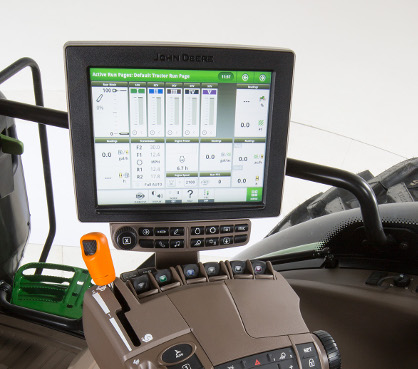 4600 CommandCenter 25.4-cm (10-in.) display
4600 CommandCenter 25.4-cm (10-in.) display
Benefits
- Easy-to-change fields and guidance lines
- Custom-defined views
- On-screen help functions
- Intelligent warnings
- Context-based help
Details
| Code | Description |
| 1947 | 4200 Processor (21.3-cm [8.4-in.] display only) |
| 1946 | 4600 Processor (25.4-cm [10-in.] display only) |
| Code | Description |
| 1829 | 21.3-cm (8.4-in.) CommandCenter display (4200 Processor only) |
| 1822 | 25.4-cm (10-in.) CommandCenter display (4600 Processor only) |
| Code | Description |
| 1867 | Less application |
| 1851 | CommandCenter AutoTrac™ activation |
| 1858 | 4200 Section Control and Data Sync activation plus CommandCenter AutoTrac activation |
| 1857 | 4600 CommandCenter Premium Activation 3.0 |
| 1861 | 4600 CommandCenter Automation Activation 1.0 |
| 186S | 4600 CommandCenter Automation Activation 3.0 |
NOTE: CommandCenter AutoTrac activation stays with the tractor.
NOTE: 6155RH only available with code 1867.
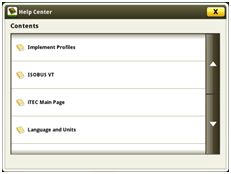 Help center main page
Help center main page
Additionally, application-based help is also available in all locations of the CommandCenter. Simply click on the (i) icon available on the title bar and it will lead directly to more information on the application currently being used.
Display options
Generation 4 CommandCenter displays are available in the following configurations:
- 21.3-cm (8.4-in.) display on the 4200 CommandCenter
- 25.4-cm (10-in.) display on the 4600 CommandCenter
For those wanting to maximize their viewing real estate, the 25.4-cm (10-in.) touchscreen color display is an excellent choice. With the 25.4-cm (10-in.) display, the title bar and all shortcut keys may be viewed at all times. Operators can monitor more items at once on the 25.4-cm (10-in.) touchscreen display.
Layout Manager
 Layout Manager selection page
Layout Manager selection page
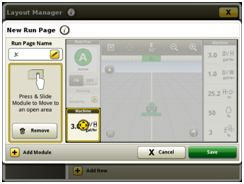 Layout Manager module build
Layout Manager module build
The Generation 4 CommandCenter features a modular-designed layout manager so an operator can easily create the structure that meets the operator’s demands. From the factory, machines are equipped with standard run pages. An unlimited amount of run pages can be added to the Generation 4 CommandCenter based on operator preference or operational needs. Toggling between run pages is as easy as swiping the screen or using the arrow buttons on the top right portion of the title bar.
Users and access
Users and access allow the owner to lock out certain functions to prevent operators from accessing or changing settings. Lock-out functions are managed with an owner-defined four-digit code.
Lockout features are available for:
- Precision Ag Technology applications
- Hitch
- Hydraulic
- Transmission
- Power take-off (PTO)
- FieldCruise™ engine controls
- Display
- Machine monitor
On-screen help and diagnostic text
There are a number of different ways to get meaningful on-screen help when navigating the Generation 4 CommandCenter. Operators can find the help icon on the shortcut bar on the bottom of every page. This icon gives detailed information on everything from tractor operation to application information. Simply select the help icon and navigate to the information section that is needed.
Work monitor
 Work monitor page
Work monitor page
The work monitor application displays the performance information about the task being performed by the machine. The user is shown averages, totals, and productivity of the machine, such as area worked, average working speed, and fuel usage. The values of the work monitor can be reset by the user at any time. Specific values of the work monitor can be configured by the user to be shown on a run page.
NOTE: The work monitor application replaces part of the universal performance monitor in previous machines.
Video capability
Tractors with a 4200 CommandCenter are equipped with one video input and tractors with a 4600 CommandCenter have two video inputs. The operator has the ability to set a variety of triggers, including reverse, PTO, hitch, and selective control valve (SCV) levers to activate the camera. The image will then appear on the CommandCenter display. The camera (video observation system) is available through JD Parts and Ag and Industrial (A & I) Products.
John Deere Generation 4 CommandCenter processors
A Generation 4 CommandCenter is made up of a processor and a display. Two processor options are available for the Generation 4 CommandCenter.
The 4600 Processor is the premium processor. Available features with the premium processor include:
- Compatible with 25.4-cm (10-in.) touchscreen display
- Two video camera inputs
- One USB input
- AutoTrac capable (machine-specific activation sold separately)
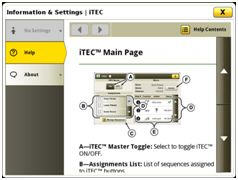 Context-based help iTEC™ main page
Context-based help iTEC™ main page
Diagnostic text and information is available for better understanding of whether applications are operating as directed.
Machine monitor
 Machine monitor page
Machine monitor page
The machine monitor application provides the user instantaneous readings about the status or condition of the machine. Values shown in the machine monitor vary by application, but typically include parameters like engine speed, coolant temperature, and ground speed. The machine monitor supports run page modules in the layout manager, allowing the user to populate specific machine parameters directly to a run page.
NOTE: The machine monitor application replaces part of the Universal Performance Monitor in previous machines.
 25.4-cm (10-in.) 4600 CommandCenter display
25.4-cm (10-in.) 4600 CommandCenter display
The 4200 Processor is base equipment on all 6R Tractors. It offers:
- Compatible with 21.3-cm (8.4-in.) touchscreen display
- One video camera input
- One USB input
- AutoTrac capable (machine-specific activation sold separately)
| Tractors | 4600 Processor | 4200 Processor |
| 6R | Option | Standard |
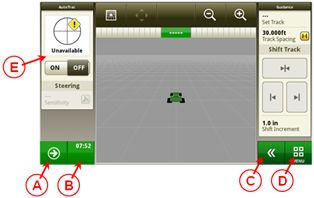 John Deere 4200 CommandCenter
John Deere 4200 CommandCenter
A. Next run page
B. Status center
C. Expand shortcut keys
D. Menu
E. Run page
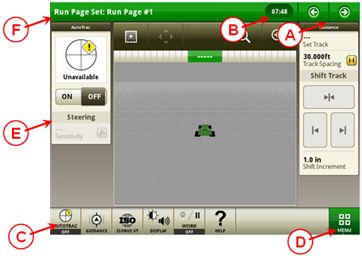 John Deere 4600 CommandCenter
John Deere 4600 CommandCenter
A. Next and previous run page
B. Status center
C. Shortcut keys
D. Menu
E. Run page
F. Title bar
Infinitely Variable Transmission (AutoPowr™/IVT™) system
Overview
The John Deere Infinitely Variable Transmission (AutoPowr/IVT) utilizes a combination of mechanical and hydrostatic power, providing stepless and continuous power across an infinitely variable range of speeds.
Single-speed lever is used for intuitive and accurate control of ground speeds as slow as 50 m/h (0.03 mph) to 40/50 km/h (25/31 mph). In model year 2015, the transmission was revised so transport speeds are reached at lower engine rpms, ultimately reducing fuel consumption and in cab noise. Software has also been revised to ensure under acceleration engine rpm is kept to a minimum within the engines peak torque band.
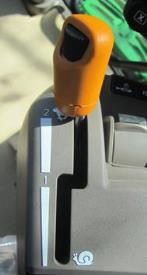 AutoPowr/IVT transmission
AutoPowr/IVT transmission
Benefits
- Easy to operate
- Four mechanical modes lead to excellent performance and reduced fuel consumption
- Revised ratios bring transport speeds at reduced engine rpm – reduced fuel consumption and increased comfort
- Precise management of forward speeds
- Less shifting time means better management of the implement
Details
- Requires 240-amp alternator (code 8743) (6110R, 6120R, and 6130R)
- Requires code electrohydraulic (EH) selective control valves (SCVs) and 240-amp alternator
- Requires braked front axle (code 6070)
- Requires hydraulic trailer brakes (code 8756)
- Requires B-speed rated tires and front fenders (8011 or 8012)
NOTE: Not available in 6155RH.
| Code | Description |
| 1552 | AutoPowr/IVT – 50 km/h (31 mph) |
Details
- Requires code EH SCVs
- Requires 240-amp alternator (code 8743) (6110R, 6120R, and 6130R)
NOTE: Not available in 6155RH.
| Code | Description |
| 1551 | AutoPowr/IVT – 40 km/h (25 mph) |
50 km/h (31 mph)
 6R in transport
6R in transport
The following features are part of the 50 km/h (31 mph) package:
- Triple-Link Suspension (TLS™) Plus system with brakes for improved braking capacity
- Rim and tire matching with fixed tread rims to minimize vibration and increase ride comfort
- Trailer brakes
- Front and rear fenders
Set-speed adjusting wheel
Overview
The set-speed adjusting wheel is the rotational thumbwheel located on the speed control lever. The wheel is quick and easy to adjust with the operator’s thumb and rotates infinitely with no stop or start position. When the operator rotates the thumbwheel, the ground speed of the tractor is increased by 0.2 km/h (0.12 mph) when the tractor is traveling below 20 km/h (12 mph). When the tractor is traveling above 20 km/h (12 mph), the tractor is increased by (1) km/h (0.6 mph). The set speed adjuster is used to set the maximum commanded forward or reverse speed in each speed band.
As the operator moves the lever within or between speed bands, the electronic management system ensures smooth, quick, and powerful acceleration or deceleration, regardless of load or ground speed.
While in motion, the operator can adjust the maximum speed of each speed band. With the lever in band one, the target maximum speed can be adjusted to 20 km/h (12 mph). With the lever in band two, the maximum speed of 40/50 km/h (25/31 mph) can be defined depending on transmission option. When stationary, all set speeds, both forward and reverse, may be adjusted while the left-hand reverser is in the power zero position.
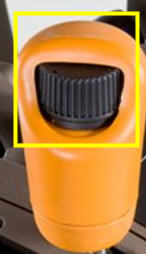 Thumbwheel located on the speed control lever
Thumbwheel located on the speed control lever
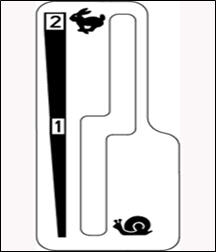 Lever slot between speed brands
Lever slot between speed brands
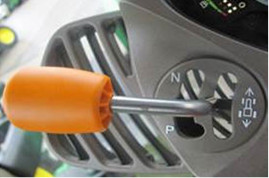 Left-hand reverser
Left-hand reverser
For tractors with CommandPRO, the left-hand reverser incorporates only forward and reverse direction selection and the lever is self-centering. The park (P) and neutral (N) positions can be selected on the CommandPRO.
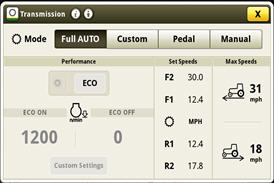 Full auto screenshot on CommandCenter display
Full auto screenshot on CommandCenter display
Custom mode
Overview
Custom mode allows the operator to customize the AutoPowr/IVT transmission settings when full auto mode is not desirable. In custom mode, operators can turn ECO on and off. This can either be done by pushing the ECO button on the side of the hand throttle module or by selecting ECO in the transmission settings page of the CommandCenter display. When accelerating with ECO on, the tractor minimizes engine speeds, which reduce acceleration aggressiveness. As a result, ECO on should reduce fuel consumption in lighter, steady loads. In contrast, when accelerating with ECO off, engine speed can be higher aggressively to maximize productivity. The higher engine speeds with ECO off better enable the tractor to quickly recover from sudden load increases and not lose as much ground speed when load increases occur.
In custom mode, the engine droop settings can be defined between 4 percent and 30 percent with PTO on and off. The higher the droop percentage, the more the engine rpm will be reduced when pulling before a transmission ratio change is made.
 Drop-down information for set speeds on CommandCenter™ display when rotating the thumbwheel
Drop-down information for set speeds on CommandCenter™ display when rotating the thumbwheel
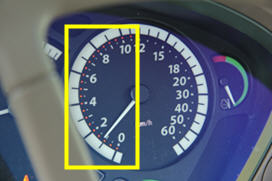 Set speed indicated in the dashboard
Set speed indicated in the dashboard
Benefits
- Quick and precise speed changes
- Fine-tuning via the speed wheel
- Two steps in the slot of the speed control lever to program two set speeds
- Speed feedback on the analog dashboard – the needle shows the actual speed, and red lights around the needle show the commanded speed
- Easy-to-handle exact-speed settings through the CommandCenter display and the speed wheel
Left-hand reverser
Overview
An easy-to-use left-hand reverser is available in all the AutoPowr/IVT transmissions. The reverser control is located at the 10 o’clock position on the steering column for intuitive control. For tractors without the CommandPRO™ joystick, the left-hand reverser incorporates the following controls:
- Forward direction selector
- Reverse direction selector
- Park (P) - Park lock (P) - Tractor cannot move and the trailer brakes are engaged. Lever must be in the (P) park position to start the tractor.
- Neutral (N) – Tractor is in a non-parked position and capable of movement.
- Power zero – Tractor is held stationary by the transmission.
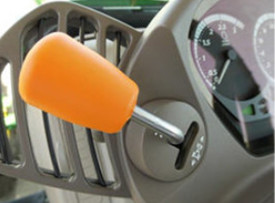 Left-hand reverser if equipped with CommandPRO
Left-hand reverser if equipped with CommandPRO
Benefits
- Tractors without CommandPRO allow for temporary stationary control of the tractor without using the brakes. For tractors with CommandPRO, ActiveZero is always in place when the tractor is not in N or P and brakes are not applied.
- Quick and easy way for the operator to change the direction of the tractor.
- Ensures that the tractor cannot be operated with the park lock on.
Electronic hand and foot throttle
Overview
The tractor ground speed is controlled via the accelerator and hand throttle. The engine rpm can be set to a specific ground speed using the hand throttle (A). The following functions are available for tractors without CommandPRO:
- Button (B) activates and de-activities the FieldCruise™ system (with two available pre-sets), which is an engine rpm limiter.
- The specific ground speed set can be set by pressing button (C); this pedal lock feature works like the cruise control on a car (only functions when foot throttle is ordered).
- Button (D) allows the operator to drive with the minimum target rpm with ECO on.
- NOTE: Button (D) is only active in custom mode.
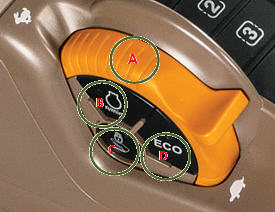 Hand throttle
Hand throttle
The following functions are available for tractors with CommandPRO:
- Button (B) and (D) activate and de-activate engine set speeds that can be set in the CommandCenter display.
- Button (C) can be used to fix the engine speed command to the current hand throttle position (no automatic engine speed control).
 Hand throttle when equipped with CommandPRO
Hand throttle when equipped with CommandPRO
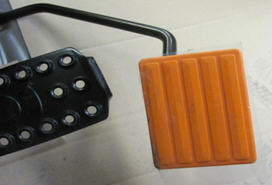 Foot throttle
Foot throttle
Benefits
- Define setting of the engine speed and its limit with the FieldCruise system
- Quick attainment of desired speed
- Pedal lock function allows command foot throttle speed to be maintained
AutoPowr/IVT selector control via CommandCenter display
Overview
The AutoPowr/IVT application setting employs four modes to take full advantage of the engine-transmission communication: full AUTO, custom, pedal and manual.
Full AUTO mode
Overview
Full AUTO mode enables the tractor to make adjustments to the transmission operating mode automatically, based on the engine and transmission speeds and the load on the tractor. This should be the AutoPowr/IVT transmission setting for 95 percent of all applications.
Full AUTO mode switches between load control and fuel economy mode seamlessly, with no involvement from the operator, as conditions and applications change. Fuel economy mode automatically switches off when the power take-off (PTO) is engaged to provide full PTO power. Operators can set the maximum forward and reverse speeds for the tractor in their particular application.
NOTE: Activation ECO is not available in full auto mode.
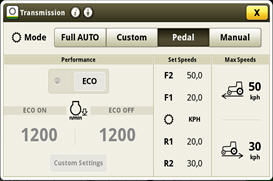 Pedal mode display on CommandCenter display
Pedal mode display on CommandCenter display
Benefits
- Pedal mode is ideal for applications like mowing, baling, or hedge cutting, where it is important to keep the engine speed at a constant rpm independent from the ground speed.
Manual mode settings
Overview
Manual mode makes the transmission and engine independent of each other. The transmission does not automatically adjust engine rpm to save fuel. This can prove to be useful in applications like loader work, where the variability of engine speed based on load is not needed.
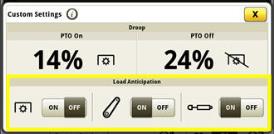 Load anticipation display on CommandCenter display
Load anticipation display on CommandCenter display
Benefits
- John Deere exclusive feature
- Tractor recognizes when additional engine rpm is needed
- Saves fuel, because the engine shuts down when no additional power is needed
Forward/Reverse relationship
Overview
Similar to the AutoQuad™ PLUS transmission, the AutoPowr/IVT transmission can also adjust the forward/reverse speed ratio. The reverse speeds can be set to a maximum of 30 percent higher and 70 percent lower than forward speeds, but only in range 1. In range 2, the forward-to-reverse speed ratio is 1:1, up to 22 km/h (14 mph). Above that, the reverse speeds will only go up to 30 km/h (19 mph).
 Section of forward/reverse relationship via CommandCenter display
Section of forward/reverse relationship via CommandCenter display
Brake with integrated AutoClutch function
Overview
With the AutoPowr/IVT transmission, no clutching is required to stop the tractor. After the brakes are released, the tractor automatically accelerates back to its previous speed (if using hand throttle). The effect of AutoClutch can also be set via the CommandCenter display.
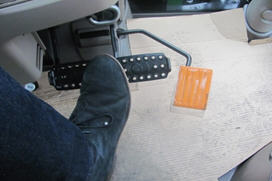 Operator presses brake pedal to stop the tractor
Operator presses brake pedal to stop the tractor
 AutoClutch sensitivity change on CommandCenter display
AutoClutch sensitivity change on CommandCenter display
Benefits
- This feature makes the AutoPowr/IVT an ideal transmission for operations that require a lot of speeds (like baling or loader work).
- Upon release of the AutoClutch, the tractor will accelerate to the previous command speed (ideal for round baling).
- Excellent modulation makes inching to implements and attachments easy.
Torque
Overview
The AutoPowr/IVT transmission is a combination of mechanical and hydraulic components that are capable of providing low speed with extremely high levels of torque:
- Allows the tractor to smoothly pull away, even under high loads
- Enhances front loader operation by delivering high torque, driving the tractor into the pile without slippage
- Retains constant working speeds with PTO implements, which have a tendency to push the tractor (spading or rotary cultivator)
Creeper mode
Creeper mode is a standard feature on the AutoPowr/IVT transmission. Down to 50 m/h (164 ft/h), the creeper mode is activated when the selected speed is below 2.1 km/h (1.3 mph) in set position 1.
When the tractor moves below 600 m/h (1968 ft/h), the engine speed is independent of travel speed. This allows the operator to choose the engine speed that best fits the task (rated speed for hydraulic or PTO usage, or low idle for fuel-saving operation). No additional power is needed.
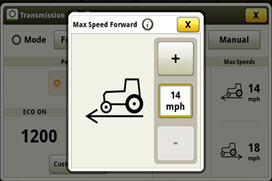 Customizing speed of direction on CommandCenter display
Customizing speed of direction on CommandCenter display
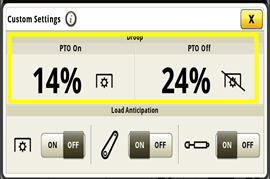 Droop setting on CommandCenter screen
Droop setting on CommandCenter screen
Benefits
- Ensure that the operator has the best driving options when required
- Independent droop settings allow the operator improved performance and flexibility
Pedal mode settings
Overview
Pedal mode allows the operator to change the tractor’s ground speed independently from the engine speed. The ground speed is controlled through use of the foot pedal while the hand throttle determines engine speed. Maximum ground speed is determined by the location of the speed control lever in the speed band. Operators can lock-in a desired ground speed without pressure on the foot pedal using the pedal lock button (as described above). To unlock the foot pedal, the operator can tap the foot pedal, press the lock button, or press the brake pedal. When releasing the foot pedal, the vehicle decelerates to a safe creep speed. To come to a complete stop, the brake pedal should be depressed.
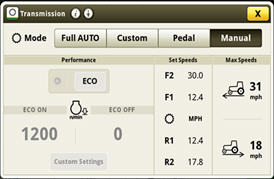 Manual mode display on CommandCenter display
Manual mode display on CommandCenter display
Load anticipation feature
Overview
The load anticipation feature allows the AutoPowr/IVT transmission to predict how much load the engine expects from the activation of the hitch or a particular SCV function.
In full AUTO mode, all load anticipation features are active. In custom mode, they can be turned on or off in the custom settings page. When an SCV or the hitch is activated, the engine speed is raised to 1500 rpm (as long as the commanded throttle position is over this value). This creates a boost in engine power which improves hydraulic performance and prepares the engine for potential load situations (for example, returning an implement to work). Also added is PTO load anticipation. If it is turned off, the engine does not react to PTO engagement and engine speed is controlled purely based on load. If turned on (in custom), when the PTO is engaged, the engine rpm will rise to throttle position or pre-defined PTO cruise setting.
CommandPRO™ joystick driving strategy
The optional CommandPRO joystick combines a unique driving strategy with reconfigurable controls.
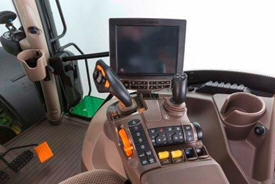 CommandARM™ controls with CommandPRO
CommandARM™ controls with CommandPRO
Layout and functions
 |
1 – travel set speed buttons 1 and 2 |
 |
4 – reconfigurable buttons and rocker switches (buttons 10 and 11, rocker switches C and D) |
Benefits
- 11 reconfigurable controls for both tractor and implement functions
- Possibility to operate tractor and ISOBUS functions at the same time on the CommandPRO joystick
- Intuitive and easy driving concept
| Code | Description |
| 2089 | Standard Cab with CommandPRO |
| 2091 | Premium Cab with CommandPRO |
| 2092 | Premium Cab with CommandPRO and cab suspension |
Default assignments
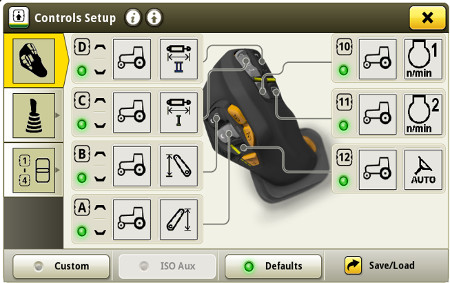
| Rocker D: selective control valve (SCV) II (if equipped) | Button 10: engine set speed 1 |
| Rocker C: SCV I (if equipped) | Button 11: engine set speed 2 |
| Rocker B: front hitch (if equipped) | Button 12: AutoTrac™ resume (if equipped) |
| Rocker A: rear hitch (if equipped) |
NOTE: For information about reconfigurability, please see operator's station functional area.
Driving strategy
The unique driving strategy is designed to deliver highest performance in combination with operator comfort making the daily work much easier and efficient.
- Pedal and joystick mode are active at the same time
- ActiveZero keeps the output speed actively at 0 km/h (0 mph) until command for acceleration is given independent of load or engine speed
- Command top and zero speed simply by one push or pull
- Unique inching control
- Three easily adjustable travel set speeds
- Two engine set speeds
- Three acceleration response settings
 Driving strategy
Driving strategy
| Forward movement | Reverse movement | |
| 1 | Accelerate | Decelerate |
| 2 | Top set speed | Zero speed |
| 3 | Decelerate | Accelerate |
| 4 | Zero speed | Accelerate |
| 5 | Activate set speed | |
| 6 | Select direction | |
| 7 | Inching speed | |
| 8 | Inching speed | |
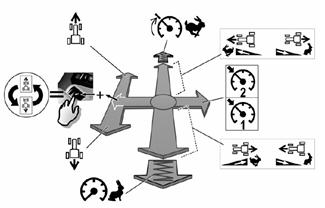 CommandPRO joystick driving functions
CommandPRO joystick driving functions
Pedal and joystick mode active at the same time
The change between using the foot pedal or the joystick can happen while driving for ease of use and comfort. The simple rule is: the higher speed command is superior. When changing from the pedal to the joystick, there is a short overlap where the joystick takes over the command from the pedal before the pedal is released. Similar, when changing from joystick control to the foot pedal, the driver needs to push the foot pedal to the point of speed where the joystick is before it can take over.
Inching control
The inching control of the CommandPRO joystick simplifies the attachment of implements. Once the joystick is pushed into the inching range, the tractor moves very slowly in the selected direction. Speed is dependent on the joystick position and can be speed between 0 and 2 km/h (0 and 1.2 mph). Maximum speed of the inching range can be set to 5 km/h (3.1 mph) with the travel speed adjustment wheel.
Unlike the main range, releasing the joystick means the speed is reduced until the vehicle stops completely. This allows the operator to fully focus on the implement and quickly stop if required.
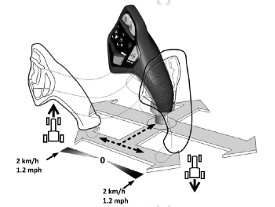 Inching control on CommandPRO joystick
Inching control on CommandPRO joystick
Travel set speeds
The travel set speed buttons on the CommandPRO joystick allow the operator to set two set speeds. The operator has to preselect the desired set speed by pushing the travel set speed button 1 or 2 and once the joystick is pushed to the right, the set speed is activated and the travel speed will be adjusted until the set speed is achieved. Additionally, the operator can set a maximum travel speed through the travel speed adjustment wheel or in the CommandCenter™ display.
There are different ways to set or adjust the set speeds:
- In the CommandCenter display
- If current travel speed should be saved as a set speed, press and hold either one of the buttons for 2 seconds and the speed is saved
- When already using a set speed, it can be adjusted with the travel speed adjustment wheel
The operator can also set a dedicated set speed when changing the travel direction. For example, the tractor is driving forward at 10 km/h (6.2 mph) and for reversing the reverse shuttle shift speed is set to 5 km/h (3.1 mph). This means when the shuttle shift takes place, the tractor will accelerate to 5 km/h (3.1 mph) in reverse direction. This function can be turned on/off and set to the dedicated speed in the CommandCenter display.
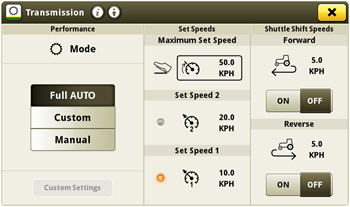 Set speeds and shuttle shift speeds in the CommandCenter
Set speeds and shuttle shift speeds in the CommandCenter
Acceleration response
The three settings for acceleration and deceleration with the CommandPRO joystick can be changed by pressing acceleration response button. Three light-emitting diodes (LEDs) next to the set button indicate the currently activated setting.
- Smooth acceleration and deceleration – one LED glows
- Normal acceleration or deceleration – two LEDs glow
- Rapid acceleration and deceleration – three LEDs glow
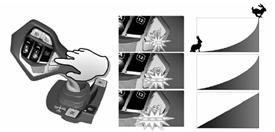 Three settings for acceleration and deceleration
Three settings for acceleration and deceleration
The settings influences the following:
- Characteristics of increase and decrease in speed for both CommandPRO joystick and foot pedal
- Speed change value when flicking the CommandPRO lever forward or backward (triggering).
- 0.2 km/h (0.12 mph) in slow acceleration mode
- 0.5 km/h (0.31 mph) in normal acceleration mode
- 1 km/h (0.62 mph) in rapid acceleration mode
- Acceleration characteristics when activating a travel set speed
- Tractor behavior when commanding a change in direction of travel
To ensure comfortable and reliable deceleration of the tractor with both the foot pedal and the CommandPRO joystick the tractor is equipped with unique technology. The engine overspeed protection ensures that both transmission and engine are not overloaded when decelerating. Additionally, the anti-jackknife technology compares wheel speed of front and rear wheels when decelerating through the joystick, as this means that the front brakes are not applied but only through the rear axle. If the front wheels are moving quicker, the transmission automatically adjusts to ensure the same wheel speed and avoid the jackknife situation.
Park lock and neutral
The park lock is disengaged automatically when commanding any direction of travel. Additionally, it engages automatically when the driver leaves the driver seat while the tractor is stationary. If the tractor is equipped with a trailer brake, this logic also applies for the trailer brake.
The buttons for the park lock and neutral position are next to the CommandPRO joystick on the CommandARM controls. There is no park lock or neutral position available in the left-hand reverser.
 CommandPRO joystick with neutral and park position
CommandPRO joystick with neutral and park position
Rear-mounted selective control valves (SCVs)
Overview
To control a rear implement, up to six SCVs or five SCVs plus Power Beyond can be ordered (6145R-6250R). For (6110R- 6130R) up to five SCVs or four SCVs plus Power Beyond can be ordered. The SCVs can be controlled electrically. Up to four mechanical SCVs are available, in combination with Power Beyond. All mechanical or electrical SCVs feature four positions - neutral, raise, lower, and float.
Benefits
- Release levers make disconnecting hydraulic hoses easy
- Relocated valves improve operator's visibility to the rear hitch
- Up to six rear SCVs give operators total flexibility
| Code | Description | Information | Availability |
| 3312 | Two mechanical SCVs – premium | Premium couplers with high-pressure relief lever. Two mechanical SCVs 450 Series. Only in combination with PowrQuad™ Plus transmission or AutoQuad™ Plus transmission. Only available on 6110R - 6130R. |
6110R, 6120R, 6130R |
| 3332 | Three mechanical SCVs - premium | Premium couplers with high-pressure relief lever. Only in combination with PowrQuad Plus or AutoQuad Plus. | 6110R, 6120R, 6130R, 6145R, 6155R, 6175R, 6195R, 6215R |
| 3311 | Two electronic SCVs - premium | Premium couplers with high-pressure relief lever. | 6110R, 6120R, 6130R |
| 3331 | Three electronic SCVs - premium | Premium couplers with high-pressure relief lever. | 6110R, 6120R, 6130R, 6145R, 6155R, 6175R, 6195R, 6215R, 6230R, 6250R |
| 3341 | Four electronic SCVs - premium | Premium couplers with high-pressure relief lever. | 6110R, 6120R, 6130R, 6145R, 6155R, 6175R, 6195R, 6215R, 6230R, 6250R NOTE: Not available for 6155RH. |
| 3351 | Five electronic SCVs – premium | Premium couplers with high-pressure relief lever. When ordered with right-hand console, (code 2055) also electrical joystick (code 841L) for operation of rear SCVs or electrical midstack SCV (code 8922, 8923, 8914 or 8915) is required. A maximum of four SCVs can be operated via paddle pot at right-hand console. | 6110R, 6120R, 6130R, 6145R, 6155R, 6175R, 6195R, 6215R, 6230R, 6250R NOTE: Not available for 6155RH. |
| 3361 | Six electronic SCVs – premium | Premium couplers with high-pressure relief lever. Not with right-hand console (code 2055). Not in combination with electrical joystick (code 841L) and any option with electrical joystick. | 6145R, 6155R, 6175R, 6195R, 6215R, 6230R, 6250R NOTE: Not available for 6155RH. |
Mechanical control valves
Overview
The tractor may be equipped with one type of mechanical control valves: premium (450 Series).
Premium-couplers control valves also have an additional lock function (position 3), which holds the control lever in the raise or lower position until the pressure in the oil circuit has reached a predetermined value (e.g., when the control cylinder has reached its end position).
In position 2, the control lever returns to neutral as soon as it is released and is the setting for normal hydraulic operation.
If an implement is connected, pressure connection has to be connected to the lower coupler. With standard SCVs, a valve prevents sudden loss of pressure caused by leakage when the engine is shut off.
On premium SCVs, the likelihood of leakage is further diminished.
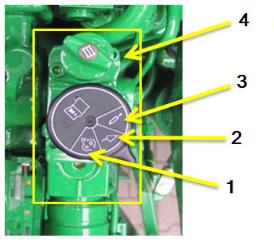 Premium mechanical control valve (premium)
Premium mechanical control valve (premium)
- Position 1
- Position 2
- Position 3
- Hydraulic oil flow control
Electrical control valves
Overview
The tractor may be equipped with the premium (450 Series) control valves. All main characteristics can be controlled by the CommandCenter™ display.
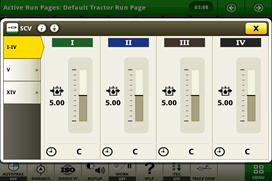 CommandCenter hydraulics option
CommandCenter hydraulics option
Example options of rear valve configuration
 3351 – five electronic SCVs (five SCV premium)
3351 – five electronic SCVs (five SCV premium)
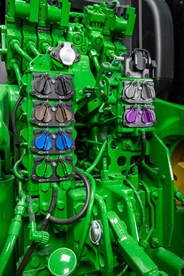 3361 – six electronic SCVs (six SCV premium)
3361 – six electronic SCVs (six SCV premium)
Hydraulic control options
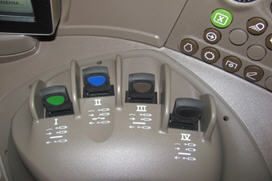 E-SCV controls on the right-hand console
E-SCV controls on the right-hand console
 M-SCV controls on the right-hand console
M-SCV controls on the right-hand console
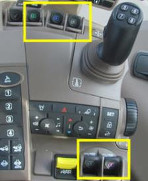 E- SCV controls on CommandARM™ controls
E- SCV controls on CommandARM™ controls
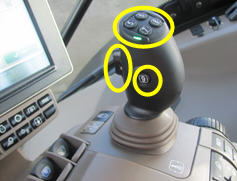 E-SCV controls on optional joystick (reconfigurable)
E-SCV controls on optional joystick (reconfigurable)
Hydraulic set up
Shortcut button right-hand console
Overview
Simply push the hydraulic symbol on the right-hand side console or the CommandCenter and the CommandCenter display shows a setup menu to:
- Monitor valve status - detent, float, or neutral
- Adjust maximum flow and detent (combine for both direction or separate extent and retract adjustment)
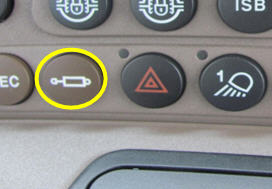 Hydraulic shortcut button on right-hand console
Hydraulic shortcut button on right-hand console
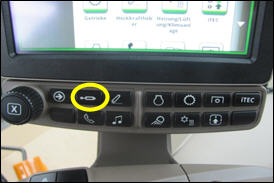 Hydraulic shortcut button CommandCenter
Hydraulic shortcut button CommandCenter
Detent setup
Overview
- Time detent - this is particularly useful when repeat SCV operations are performed, such as lowering a mower-conditioner plow or cycling planter markers.
- Continuous flow detent - this is particularly useful when a hydraulic motor is used, such as on an air seeder.
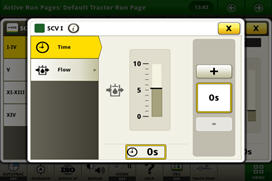 Detent setup
Detent setup
SCV flow setup
Overview
SCV flow rate can be programmed between 0.04 and 10 allowing fine tuning for implements with different hydraulic requirement.
Behavior can be set between linear (red), progressive (green), or a combination (yellow) for exact flow modulation and precise valve management.
- Linear means that the distance travelled by the SCV/ICV corresponds to the distance travelled by the control lever/multifunction lever
- Progressive means that initially the distance travelled by the SCV/ICV is less than that travelled by the control lever/multifunction lever (giving a more sensitive start to the movement)
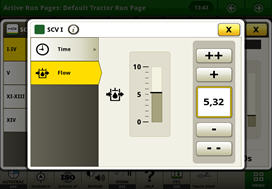 Flow setup
Flow setup
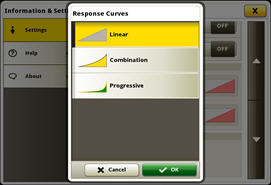 Three flow options
Three flow options
 Flow characteristic setup
Flow characteristic setup
Combination is an intermediate stage between the two settings listed above.
ComfortView™ cab operator environment
Overview
ComfortView cabs feature a modern, automotive-style instrument panel as base equipment. The instrument pod has two large analog dials for engine and tractor speed, as well as two smaller dials that display fuel level, diesel exhaust fluid (DEF) level, and coolant temperature. The steering column and dash are adjustable to suit the operator's needs. The column tilts toward the operator and a lever on the left-hand side allows for the column to telescope out to the desired level.
A dimming mode automatically reduces the brightness of the instrument illumination when the tractor lights are used.
Steering column control panel
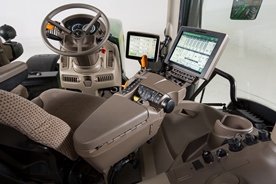 Cab and controls of 6R Tractor
Cab and controls of 6R Tractor
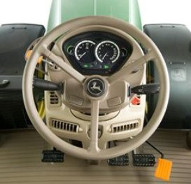 Steering column on 6R Tractor
Steering column on 6R Tractor
Instrumentation control panel
Overview
The instrumentation panel has a row of information and warning lights across the bottom to monitor all important tractor functions. A three-stage warning system first gives information, then gives warnings, and finally, gives a stop alarm to prevent damage from occurring in the event of a component malfunction. An integrated power take-off (PTO) over-speed warning is incorporated into the diagnostics to ensure proper operation.
 Instrumentation control panel
Instrumentation control panel
Dash instrument panel controls include:
| Left side | Right side |
| Left-hand reverser | Two-speed and optional intermittent wiper |
| High-/low-beam switch | Key start/stop |
| Hazard switch | Road/work lights on/off |
| Self-cancelling turn signals/horn |
In-cab storage
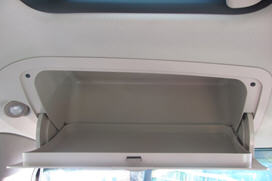 Overhead storage compartment
Overhead storage compartment
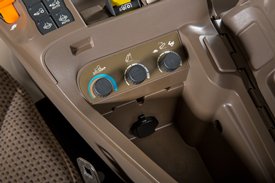 CommandARM™ console storage compartment
CommandARM™ console storage compartment
CommandARM controls
Overview
The 6R Series features a redesigned CommandARM console with all key vehicle functions in one place. The updated CommandARM layout is only available with Infinitely Variable Transmission (IVT™) and DirectDrive transmissions. The base 21.3-cm (8.4-in.) 4200 CommandCenter™ Display or optional 25.4-cm (10-in.) (4600 CommandCenter Display is fully integrated onto the CommandARM and offers fast adjustment of additional tractor functions.
The CommandARM design allows for 37.5 degrees of total seat swivel and adjustable positioning matching the operator’s preference. (30 degrees right and 7.5 degrees left).
Hydraulic and hitch controls utilize fingertip paddle pots for raise/lower and extend/retract functions. The CommandARM offers up to a maximum of six electronic selective control valves (E-SCVs) (without electronic joystick). The optional electrical joystick replaces fingertip paddle pots for control of selective control vales (SCVs) and allows for programmable hydraulic functionality according to operator preference. A maximum of five E-SCVs can be ordered with the electronic joystick. For tractors with an IVT transmission, the CommandPRO™ joystick is available. Its 11 reconfigurable buttons enable the operator to have all necessary controls accessible without hand movements (for details, click here).
Controls for radio, lights, rotary beacon, and hazard flashers are located to the center right on the CommandARM along with PTO for front (if equipped) and rear PTO. Additionally, located on the right side of the CommandARM is an encoder wheel which allows for finite positioning of the rear 3-point hitch. There are three buttons near the encoder for set lock and return to height. Adjustment knobs for the 3-point hitch are located under the cover for the CommandARM storage compartment and allow for adjustment of the rate of drop, hitch height limit, and depth control.
The transmission control and throttle are placed on the left side of the CommandARM closest to the operator for convenient setting and adjustment. The throttle design incorporates buttons which control engine cruise speed, pedal lock/cruise control, and transmission Eco settings (for more information, refer to the AutoPowr™ or DirectDrive transmissions pages).
Located just to the right of the throttle is the auto-steer activation button and four sequence controls for iTEC™ functions. Behind the iTEC sequence controls are buttons which control the activation and deactivation of mechanical front-wheel drive (MFWD) and differential lock.
Differential lock can also be activated by foot switch on the cab floor. A feature in the 6R Series Tractor is auto steering angle dependent differential lock button.
Operators can easily identify controls by icons located near levers, and each functional area is color coded.
Functions:
- Motion (throttle, transmission) - orange
- MFWD and hydraulics (hitch and SCVs) - black
- PTO - yellow
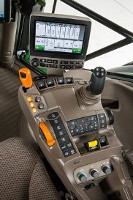 ComfortView cab with CommandARM console
ComfortView cab with CommandARM console
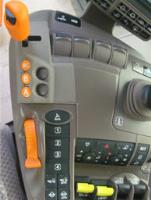 Close up of controls on the CommandARM
Close up of controls on the CommandARM
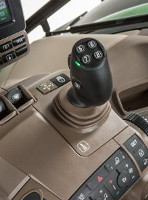 Optional integrated crossgate joystick
Optional integrated crossgate joystick
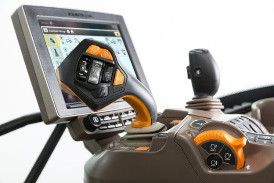 CommandPRO controls (IVT only)
CommandPRO controls (IVT only)
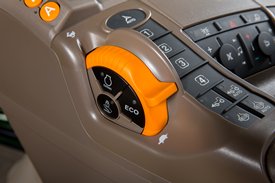 Hand throttle feature
Hand throttle feature
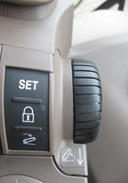 3-point hitch control layout
3-point hitch control layout
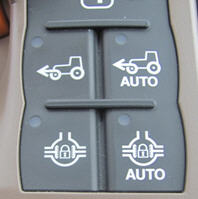 Integrated differential lock features
Integrated differential lock features
Benefits
- All main tractor functions in one place
- Hand throttle module with integrated cruise control/pedal lock and Eco function
- Integrated reconfigurable joystick
- All controls and display move with the operator's movement or motion
- Availability of optional 25.4-cm (10-in.) 4600 CommandCenter Display
- Integrated storage compartment with hitch controls
Right-hand console controls
Overview
The right-hand control console is angled for operator comfort and ease of operation. The design of the right-hand console is controlled by the type of SCVs chosen.
Mechanically actuated valves are controlled by traditional levers, while electronically actuated valves are controlled by fingertip paddle pots. Controls for the ComfortView cab are grouped by function on the right-hand console.
The modular console panel provides individual access to hand throttle, transmission controls, MFWD switch (if equipped), hitch command console, load/draft control, SCV, and PTO controls.
The console is also the location of the CommandCenter display. The CommandCenter allows the operator to customize important tractor functions.
This option requires a PowrQuad™ or AutoQuad™ transmission.
 ComfortView cab right-hand console (AutoQuad transmission is shown)
ComfortView cab right-hand console (AutoQuad transmission is shown)
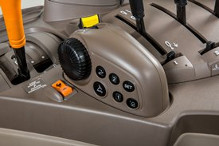 Hitch control module on right-hand console
Hitch control module on right-hand console
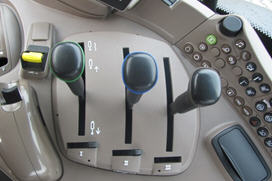 M-SCV controls on the right-hand console
M-SCV controls on the right-hand console
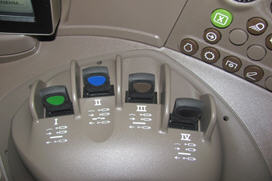 E-SCV controls on the right-hand console
E-SCV controls on the right-hand console
Benefits
- Ergonomic placement of controls to match arm movements
- Integrated hitch control module with draft wheel
Cab packages
Overview
The 6R Tractors have seven cab packages designed to match producers' operations. There are three levels of comfort - economy, standard, and premium. There are two control configurations available: a right-hand console for the PowrQuad PLUS or AutoQuad PLUS transmissions and the CommandARM console for the IVT and DirectDrive transmissions. There is an option for hydraulic cab suspension for the premium package. Below is a chart showing the available packages and what is included in each package.
Benefits
- Easy ordering of cab features
- Built-in comfort and convenience
Details
Base features in all cab packages:
- Power outlet
- Seven-pin signal interface socket
- Multi-power outlet strip
- Inner rear view mirror
- Cup holder on rear right-hand cornerpost
- Front wiper and washer
- Overhead compartment with one slot
- Overhead storage compartment on left-hand side
- Courtesy light, coat hook, floor mat
- External starting connectors (outside under right-hand door)
- iTEC control (code 8216)
Cab packages for 6110R, 6120R, 6130R, 6145R, 6155R, 6175R, 6195R, and 6215R
| Cab packages | Economy right-hand console |
Standard right-hand console |
Standard CommandARM |
Premium right-hand console | Premium CommandARM |
Premium right-hand console and cab suspension |
Premium CommandARM and cab suspension |
Standard cab with CommandPRO | Premium cab with CommandPRO | Premium cab with CommandPRO and cab suspension |
| Package code | 2050 | 2057 | 2060 | 2063 | 2064 | 2067 | 2068 | 2089 | 2091 | 2092 |
| Two panorama doors (left-hand and right-hand sides) | X | X | X | X | X | X | X | X | X | X |
| Standard seat (Grammer®) | X | X | X | X | --- | --- | --- | X | --- | --- |
| Premium seat (Grammer DDS) | --- | --- | --- | --- | X | X | X | --- | X | X |
| Instructional seat | X | X | X | X | X | X | X | X | X | X |
| Bottle holder | X | X | X | X | X | X | X | X | X | X |
| Mirrors - right hand and left hand - manually adjustable and telescopic | X | X | X | --- | --- | --- | --- | X | --- | --- |
| Wide-angle mirrors - right hand and left hand - electrically adjustable | --- | --- | --- | X | X | X | X | --- | X | X |
| Front sun visor | X | X | X | --- | --- | --- | --- | X | X | X |
| Front and rear roller blind | --- | --- | --- | X | X | X | X | --- | --- | --- |
| Rear wiper and washer | --- | X | X | X | X | X | X | X | X | X |
| Manual temperature controls | X | X | X | --- | --- | --- | --- | X | X | X |
| Automatic temperature controls | --- | --- | --- | X | X | X | X | --- | X | X |
| Hydraulic cab suspension | --- | --- | --- | --- | --- | X | X | --- | --- | X |
| CommandPro | --- | --- | --- | --- | --- | --- | --- | X | X | X |
| Leather comfort package | --- | --- | --- | --- | --- | X | X | --- | X | X |
*6155RH right-hand console only
Cab packages for 6230R and 6250R
| Cab packages | Standard CommandARM | Premium CommandARM | Premium CommandARM and cab suspension | Standard cab with CommandPRO | Premium cab with CommandPRO | Premium cab with CommandPRO and cab suspension |
| Package code | 2060 | 2064 | 2068 | 2089 | 2091 | 2092 |
| Two panorama doors (left-hand and right-hand sides) | X | X | X | X | X | X |
| Standard seat (Grammer) | X | --- | --- | X | --- | --- |
| Premium seat (Grammer DDS) | --- | X | X | --- | X | X |
| Instructional seat | X | X | X | X | X | X |
| Bottle holder | X | X | X | X | X | X |
| Mirrors - right hand and left hand - manually adjustable and telescopic | X | --- | --- | X | --- | --- |
| Wide-angle mirrors - right hand and left hand - electrically adjustable | --- | X | X | --- | X | X |
| Front sun visor | X | --- | --- | X | X | X |
| Front and rear roller blind | --- | X | X | --- | --- | --- |
| Rear wiper and washer | X | X | X | X | X | X |
| Manual temperature controls | X | --- | --- | X | X | X |
| Automatic temperature controls | --- | X | X | --- | X | X |
| Hydraulic cab suspension | --- | --- | X | --- | --- | X |
| CommandPRO | --- | --- | --- | X | X | X |
| Leather comfort package | --- | X | X | --- | X | X |
Grammer is a trademark of Grammer AG Aktiengesellschaft.
PowerTech™ PVS/PSS Stage 4 engine
Overview
John Deere 6R Series Tractors feature the reliable and proven PowerTech PVS 6.8L and PSS 4.5L and 6.8L engines. These air-to-air aspirated engines deliver a power bulge above rated power to provide excellent torque in demanding applications.
Key features:
- Series turbochargers (PSS only)
- Variable geometry turbocharger (VGT)
- Air-to-air after cooling
- High-pressure common rail (HPCR) fuel system
- Engine control unit (ECU)
PowerTech PSS/PVS engine identification
 |
After treatment
|
Turbocharger
|
|
Technology
|
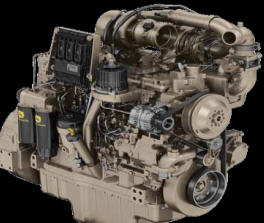 PowerTech PSS 6.8L engine
PowerTech PSS 6.8L engine

Benefits
- A constant power range of 2100 rpm down to 1500 rpm
- Power bulge of 10 percent
- Greater tractor productivity
- Responsive power reducing the need to downshift the transmission
Details
To match the engine power characteristics and improve the operation economy of the machine, the rated engine speed is 2100 rpm.
Series turbochargers
Overview
The PowerTech PSS 4.5L and 6.8L utilizes two turbochargers – a VGT and a fixed geometry turbocharger, providing the torque rise and engine response needed to meet varying load conditions.
Fresh air is first drawn into the low-pressure fixed geometry turbocharger and compressed to a higher pressure. The compressed, higher pressure air is then drawn into the high-pressure VGT, where the air is further compressed. By splitting the work between two turbochargers, both can operate at peak efficiency and at slower rotating speeds.
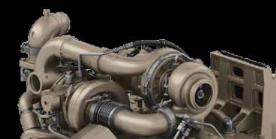 PowerTech PSS engine series turbochargers
PowerTech PSS engine series turbochargers

Benefits
- Deliver high power density
- More low-speed torque and responsiveness to meet varying load conditions
VGT
Overview
The VGT is electronically controlled and actuates the turbo vanes as required to maintain peak engine performance.
The turbocharger’s vanes are in the exhaust flow. The opening or closing of the vanes changes the outlet volume and airflow speed against the turbocharger turbine. When exhaust flow is low, the vanes are partially closed. This partial closure increases the pressure against the turbine blades to make the turbocharger spin faster and generate more boost pressure.
The ability to keep the airflow at optimum levels provides more consistent engine boost pressure and the ability to respond to load quickly across the entire engine rpm range. This system is without the turbo lag that can be found on some engines.
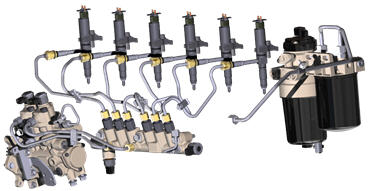 High-pressure common rail
High-pressure common rail

Benefits
- Instantly respond to load changes reducing the need to change gears
- Improved fluid economy
Engine control unit (ECU)
Overview
The ECU uses signal inputs from sensors and pre-programmed performance modeling to control critical engine functions such as fuel quantity, injection timing, air-to-fuel ratio, multiple fuel injections, amount of cooled exhaust gas recirculation (EGR), and a host of other control parameters.
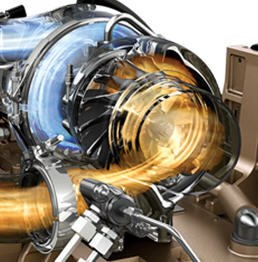 PowerTech VGT
PowerTech VGT

Benefits
- Increased low rpm torque
- Quicker response to load
- Increased peak torque
- Improved fluid economy
- Improved performance at high altitudes
Air-to-air after cooling
Overview
Air-to-air after cooling lowers the intake manifold air temperature and provides more efficient cooling while reducing cylinder firing pressure and temperatures for greater engine reliability. Since lower temperature air is denser, a higher volume of air flows into cylinders so the engine is capable of meeting the increasing horsepower demands. Lowering the intake manifold and cylinder temperatures also aid in lowering the combustion temperature, which lowers the NOx produced as a result.
Benefits
- Higher horsepower
- Less NOx production
HPCR fuel injection system
Overview
Every PowerTech PSS 4.5L and 6.8L engine utilizes a HPCR fuel system to efficiently supply fuel to injectors. The high-pressure fuel pump instantly responds to requirements for more or less fuel flow or pressure. This electronically controlled, high-pressure pump delivers pressure on demand according to the application requirements. Pressure on demand ensures an efficient injection system resulting in high-injection pressure independent of engine speed.
 ECU
ECU

Benefits
- Optimized fluid economy
- Maximum engine performance
Details
Each injector is controlled individually by the ECU. The ECU turns the injector on and off during each firing cycle to control the fuel delivery into each cylinder.
Load and speed sensing allows each cylinder’s fuel delivery rate to be adjusted independently at the individual injector. With each injection cycle, the ECU can make the following adjustments on the go:
- Number of injections
- Fuel pressure in the common rail
- Start of injection
- Duration of injection
This management system is connected to the transmission, allowing the engine and transmission to respond simultaneously.
Cold weather and high-altitude compensation are also precisely controlled for quality starts regardless of weather and maximum performance at high elevations. The ECU also features improved diagnostic capabilities. It is faster, has more working memory, and is responsible for monitoring and executing all aspects of the Integrated Emission Control System.
Lighting options provide maximum visibility in every direction
Overview
Lights on the 6R Series Tractors have been positioned and designed to provide maximum visibility to the front, sides, and rear of the tractor to increase productivity in any operating condition. The cab lighting pattern provides 330 degrees of coverage while the hood lighting provides the remaining 30 degrees for completely programmable, 360-degree, stadium-style lighting.
Base lighting
- Two HB3 hood road lights - low beam (A)
- Two HB3 hood road lights - high beam (B)
- Two HB3 hood outer work lights (C)
- Turn signals beltline mounted with clearance lights (E)
- Turn signals fender mounted (Q)
- Brake lights rear fender mounted (R)
- Two HB3 halogen inner front-roof-mounted adjustable work lights (H) / In an panorama roof the work light represented as (G)
- Two HB3 halogen inner rear-roof-mounted adjustable work lights (N)
Code |
Hood |
Belt |
Front roof |
Side |
Rear roof |
Fender |
|||||||||||
A |
B |
C |
F |
E |
G |
H |
K |
I |
L |
N |
O |
M |
P |
Q |
R |
||
| * Base package - with non-panorama roof | HB3 | HB3 | HB3 | HB3 | HB3 | HB3 | HB3 | HB3 | HB3 | ||||||||
| Light package - Standard | 873F | HB3 | HB3 | HB3 | HB3 | HB3 | LED | X | LED | HB3 | HB3 | HB3 | HB3 | HB3 | HB3 | ||
| Light package - Premium | 873E | HB3 | HB3 | HB3 | HB3 | HB3 | LED | X | LED | HB3 | LED | HB3 | HB3 | HB3 | HB3 | ||
| Light package – Base panorama roof code (878W) | HB3 | HB3 | HB3 | HB3 | HB3 | HB3 | HB3 | HB3 | |||||||||
| Light package - Standard - panorama roof | 873A | HB3 | HB3 | HB3 | HB3 | HB3 | LED | X | HB3 | HB3 | HB3 | ||||||
| Lighting package – Panorama light package | 873C | HB3 | HB3 | HB3 | HB3 | HB3 | LED | X | HB3 | LED | HB3 | HB3 | |||||
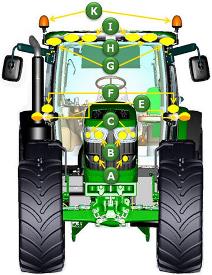 Lighting identification from front view of tractor
Lighting identification from front view of tractor
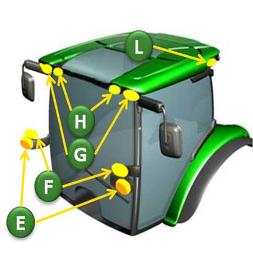 Lighting availability on panorama roof
Lighting availability on panorama roof
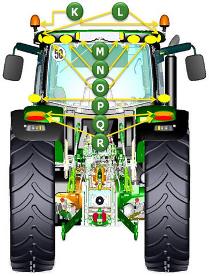 Lighting identification from rear view of tractor
Lighting identification from rear view of tractor
Selecting the lighting mode
Overview
Operators can quickly select a lighting mode on the steering console by operating a rotary switch. The four settings available are:
- Light switch in the off position
- Headlights, taillights, and warning lights in the on position
- Headlights in the on position
- Headlights and work lights in the on position (depending on CommandCenter™ assignments)
 Lighting control switch on dashboard
Lighting control switch on dashboard

Benefits
- Easy to locate and operate
- Small and compact design
Programmable lighting
Overview
The CommandCenter allows operators to customize two different light programs. The operator can switch between the two programs with the push button. Also standard on the 6R Tractors is the battery power-saver feature.
When the engine is off and the outside lights have been left on, this feature is designed to avoid battery run-down. After the lights have been left on for 30 minutes and the key is in the off position, the lights will cycle, or blink on and off five times as an alert. The lights will continue to illuminate for one more minute and then automatically shut off to protect the battery.
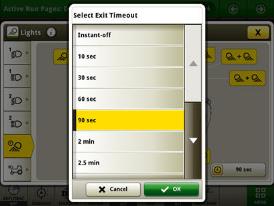 CommandCenter programmable time out lighting
CommandCenter programmable time out lighting
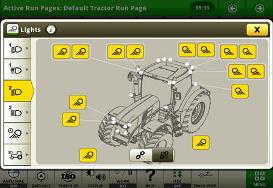 CommandCenter programmable lights page
CommandCenter programmable lights page
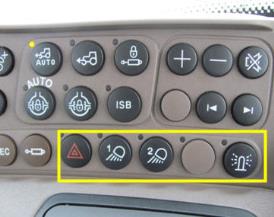 Beacon lights/hazard warning lights, work light 1 and 2 location on right-hand console
Beacon lights/hazard warning lights, work light 1 and 2 location on right-hand console
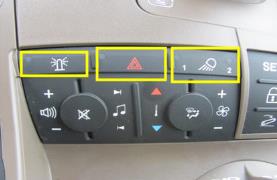 Beacon lights/hazard warning lights, work light 1 and 2 location on CommandCenter
Beacon lights/hazard warning lights, work light 1 and 2 location on CommandCenter
Benefits
- The John Deere light programming adds high performance to the operator.
- Individual light selection adds to high operator performance to prevent blinding other operators when two machines are working close to each other.
- Improved uptime due to 360-degree lighting.
Additional lights
Overview
Additional lighting is available to match various applications and ensure maximum around-the-clock productivity. Optional LED lighting technology provides extreme brightness and a daylight color output for excellent definition of the field.
The LED lights provide 40 percent greater coverage width and 10 percent more light coverage in the rear. LED lighting packages use 45 percent less amps than standard halogen lights and have an increased life expectancy over HID lights which leads to lower costs of ownership over the life of the tractor.
Beacon light for added visibility
Overview
One beacon light is mounted on the front of the cab to provide a rotating warning light for road traveling and added visibility.

Benefits
- To warn other road users of the presence of a large machine on the road.
- Easily removed, with no tools required, when approaching height restricted areas.
- Waterproof to ensure good performance when required.
- The beacon has a degree of flexible movement, and are not completely static, and can withstand the impact of objects such as tree branches.
Details
- Front cab is roof mounted.
- A second beacon light can be field installed on the right side of the cab roof.
Triple-Link Suspension (TLS™) Plus: More than comfort, it is a performance feature
More productivity - greater operator's comfort
CommandCenter™ console TLS Plus provides exclusive front suspension using a hydropneumatic self-leveling system to increase productivity and improve ride dramatically. TLS Plus provides more control over the front suspension of the tractor. In the field, the TLS Plus front suspension maintains ground-to-tire contact, enabling more power to the ground.
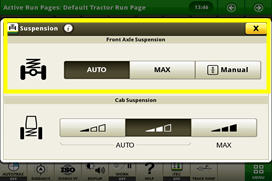 Front axle adjustment on CommandCenter
Front axle adjustment on CommandCenter
Auto mode
The TLS Plus reacts to inputs, which provides the best comfort and stability. Inputs include travel speed, implement weight, draft characteristics, and braking activity. The TLS Plus activates whenever the tractor exceeds 1.5 km/h (0.9 mph).
Maximum mode
The suspension is set to maximum hardness, which is preferable for front loader operation. This allows the operator to adjust the suspension for different situations. If the tractor exceeds 35 km/h (22 mph), the hardness is reduced to provide greater driving comfort. When dropping below 25 km/h (15 mph), maximum is reactivated.
Manual mode
This setting can be useful when attaching mounted implements to the front hitch. When activated, the axle settles in its mid position and then can be raised or lowered manually with the touchscreen or shortcut buttons F and G. The manual setting is overridden when the travel speed exceeds 5 km/h (3 mph) and returns to the previously selected setting of automatic or maximum.
The system
|
First link: vertical linkage Two double-acting hydraulic cylinders control the vertical movement of the axle, which leads to excellent sensitivity. |
|
Second link: longitudinal linkage |
|
Third link: lateral linkage This third link holds the axle laterally. These few simple components ensure excellent suspension quality and reliability with reduced maintenance. |
A full stroke of the suspension typically takes 1 second, allowing the system time to distinguish between typical terrain inputs or level changes. This prevents overreactions.
In addition to active central leveling of the suspension, the John Deere TLS Plus adopts a constantly variable rod side pressure by using a closed loop system. When the suspension reacts at a different frequency, which could be detrimental to driver comfort, the system then fine-tunes the rod side pressure, changing the spring stiffness and improving the ride behavior.
*Not available in 6155RH
Features
CommandCenter™ display
Overview
The Generation 4 CommandCenter creates the primary user interface for 6R Series Tractors. The Generation 4 CommandCenter provides an excellent, user-savvy operating experience.
Producers can also use a variety of implements with the Generation 4 CommandCenter as it is ISOBUS virtual terminal (VT) capable.
Expect machine productivity gains, along with increased operator confidence, thanks to a simple, customizable interface. The reliability of the Generation 4 CommandCenter also aids in optimal operating experience and maximizes uptime.
 4200 CommandCenter 21.3-cm (8.4-in.) display
4200 CommandCenter 21.3-cm (8.4-in.) display
 4600 CommandCenter 25.4-cm (10-in.) display
4600 CommandCenter 25.4-cm (10-in.) display
Benefits
- Easy-to-change fields and guidance lines
- Custom-defined views
- On-screen help functions
- Intelligent warnings
- Context-based help
Details
| Code | Description |
| 1947 | 4200 Processor (21.3-cm [8.4-in.] display only) |
| 1946 | 4600 Processor (25.4-cm [10-in.] display only) |
| Code | Description |
| 1829 | 21.3-cm (8.4-in.) CommandCenter display (4200 Processor only) |
| 1822 | 25.4-cm (10-in.) CommandCenter display (4600 Processor only) |
| Code | Description |
| 1867 | Less application |
| 1851 | CommandCenter AutoTrac™ activation |
| 1858 | 4200 Section Control and Data Sync activation plus CommandCenter AutoTrac activation |
| 1857 | 4600 CommandCenter Premium Activation 3.0 |
| 1861 | 4600 CommandCenter Automation Activation 1.0 |
| 186S | 4600 CommandCenter Automation Activation 3.0 |
NOTE: CommandCenter AutoTrac activation stays with the tractor.
NOTE: 6155RH only available with code 1867.
 Help center main page
Help center main page
Additionally, application-based help is also available in all locations of the CommandCenter. Simply click on the (i) icon available on the title bar and it will lead directly to more information on the application currently being used.
Display options
Generation 4 CommandCenter displays are available in the following configurations:
- 21.3-cm (8.4-in.) display on the 4200 CommandCenter
- 25.4-cm (10-in.) display on the 4600 CommandCenter
For those wanting to maximize their viewing real estate, the 25.4-cm (10-in.) touchscreen color display is an excellent choice. With the 25.4-cm (10-in.) display, the title bar and all shortcut keys may be viewed at all times. Operators can monitor more items at once on the 25.4-cm (10-in.) touchscreen display.
Layout Manager
 Layout Manager selection page
Layout Manager selection page
 Layout Manager module build
Layout Manager module build
The Generation 4 CommandCenter features a modular-designed layout manager so an operator can easily create the structure that meets the operator’s demands. From the factory, machines are equipped with standard run pages. An unlimited amount of run pages can be added to the Generation 4 CommandCenter based on operator preference or operational needs. Toggling between run pages is as easy as swiping the screen or using the arrow buttons on the top right portion of the title bar.
Users and access
Users and access allow the owner to lock out certain functions to prevent operators from accessing or changing settings. Lock-out functions are managed with an owner-defined four-digit code.
Lockout features are available for:
- Precision Ag Technology applications
- Hitch
- Hydraulic
- Transmission
- Power take-off (PTO)
- FieldCruise™ engine controls
- Display
- Machine monitor
On-screen help and diagnostic text
There are a number of different ways to get meaningful on-screen help when navigating the Generation 4 CommandCenter. Operators can find the help icon on the shortcut bar on the bottom of every page. This icon gives detailed information on everything from tractor operation to application information. Simply select the help icon and navigate to the information section that is needed.
Work monitor
 Work monitor page
Work monitor page
The work monitor application displays the performance information about the task being performed by the machine. The user is shown averages, totals, and productivity of the machine, such as area worked, average working speed, and fuel usage. The values of the work monitor can be reset by the user at any time. Specific values of the work monitor can be configured by the user to be shown on a run page.
NOTE: The work monitor application replaces part of the universal performance monitor in previous machines.
Video capability
Tractors with a 4200 CommandCenter are equipped with one video input and tractors with a 4600 CommandCenter have two video inputs. The operator has the ability to set a variety of triggers, including reverse, PTO, hitch, and selective control valve (SCV) levers to activate the camera. The image will then appear on the CommandCenter display. The camera (video observation system) is available through JD Parts and Ag and Industrial (A & I) Products.
John Deere Generation 4 CommandCenter processors
A Generation 4 CommandCenter is made up of a processor and a display. Two processor options are available for the Generation 4 CommandCenter.
The 4600 Processor is the premium processor. Available features with the premium processor include:
- Compatible with 25.4-cm (10-in.) touchscreen display
- Two video camera inputs
- One USB input
- AutoTrac capable (machine-specific activation sold separately)
 Context-based help iTEC™ main page
Context-based help iTEC™ main page
Diagnostic text and information is available for better understanding of whether applications are operating as directed.
Machine monitor
 Machine monitor page
Machine monitor page
The machine monitor application provides the user instantaneous readings about the status or condition of the machine. Values shown in the machine monitor vary by application, but typically include parameters like engine speed, coolant temperature, and ground speed. The machine monitor supports run page modules in the layout manager, allowing the user to populate specific machine parameters directly to a run page.
NOTE: The machine monitor application replaces part of the Universal Performance Monitor in previous machines.
 25.4-cm (10-in.) 4600 CommandCenter display
25.4-cm (10-in.) 4600 CommandCenter display
The 4200 Processor is base equipment on all 6R Tractors. It offers:
- Compatible with 21.3-cm (8.4-in.) touchscreen display
- One video camera input
- One USB input
- AutoTrac capable (machine-specific activation sold separately)
| Tractors | 4600 Processor | 4200 Processor |
| 6R | Option | Standard |
 John Deere 4200 CommandCenter
John Deere 4200 CommandCenter
A. Next run page
B. Status center
C. Expand shortcut keys
D. Menu
E. Run page
 John Deere 4600 CommandCenter
John Deere 4600 CommandCenter
A. Next and previous run page
B. Status center
C. Shortcut keys
D. Menu
E. Run page
F. Title bar
Infinitely Variable Transmission (AutoPowr™/IVT™) system
Overview
The John Deere Infinitely Variable Transmission (AutoPowr/IVT) utilizes a combination of mechanical and hydrostatic power, providing stepless and continuous power across an infinitely variable range of speeds.
Single-speed lever is used for intuitive and accurate control of ground speeds as slow as 50 m/h (0.03 mph) to 40/50 km/h (25/31 mph). In model year 2015, the transmission was revised so transport speeds are reached at lower engine rpms, ultimately reducing fuel consumption and in cab noise. Software has also been revised to ensure under acceleration engine rpm is kept to a minimum within the engines peak torque band.
 AutoPowr/IVT transmission
AutoPowr/IVT transmission
Benefits
- Easy to operate
- Four mechanical modes lead to excellent performance and reduced fuel consumption
- Revised ratios bring transport speeds at reduced engine rpm – reduced fuel consumption and increased comfort
- Precise management of forward speeds
- Less shifting time means better management of the implement
Details
- Requires 240-amp alternator (code 8743) (6110R, 6120R, and 6130R)
- Requires code electrohydraulic (EH) selective control valves (SCVs) and 240-amp alternator
- Requires braked front axle (code 6070)
- Requires hydraulic trailer brakes (code 8756)
- Requires B-speed rated tires and front fenders (8011 or 8012)
NOTE: Not available in 6155RH.
| Code | Description |
| 1552 | AutoPowr/IVT – 50 km/h (31 mph) |
Details
- Requires code EH SCVs
- Requires 240-amp alternator (code 8743) (6110R, 6120R, and 6130R)
NOTE: Not available in 6155RH.
| Code | Description |
| 1551 | AutoPowr/IVT – 40 km/h (25 mph) |
50 km/h (31 mph)
 6R in transport
6R in transport
The following features are part of the 50 km/h (31 mph) package:
- Triple-Link Suspension (TLS™) Plus system with brakes for improved braking capacity
- Rim and tire matching with fixed tread rims to minimize vibration and increase ride comfort
- Trailer brakes
- Front and rear fenders
Set-speed adjusting wheel
Overview
The set-speed adjusting wheel is the rotational thumbwheel located on the speed control lever. The wheel is quick and easy to adjust with the operator’s thumb and rotates infinitely with no stop or start position. When the operator rotates the thumbwheel, the ground speed of the tractor is increased by 0.2 km/h (0.12 mph) when the tractor is traveling below 20 km/h (12 mph). When the tractor is traveling above 20 km/h (12 mph), the tractor is increased by (1) km/h (0.6 mph). The set speed adjuster is used to set the maximum commanded forward or reverse speed in each speed band.
As the operator moves the lever within or between speed bands, the electronic management system ensures smooth, quick, and powerful acceleration or deceleration, regardless of load or ground speed.
While in motion, the operator can adjust the maximum speed of each speed band. With the lever in band one, the target maximum speed can be adjusted to 20 km/h (12 mph). With the lever in band two, the maximum speed of 40/50 km/h (25/31 mph) can be defined depending on transmission option. When stationary, all set speeds, both forward and reverse, may be adjusted while the left-hand reverser is in the power zero position.
 Thumbwheel located on the speed control lever
Thumbwheel located on the speed control lever
 Lever slot between speed brands
Lever slot between speed brands
 Left-hand reverser
Left-hand reverser
For tractors with CommandPRO, the left-hand reverser incorporates only forward and reverse direction selection and the lever is self-centering. The park (P) and neutral (N) positions can be selected on the CommandPRO.
 Full auto screenshot on CommandCenter display
Full auto screenshot on CommandCenter display
Custom mode
Overview
Custom mode allows the operator to customize the AutoPowr/IVT transmission settings when full auto mode is not desirable. In custom mode, operators can turn ECO on and off. This can either be done by pushing the ECO button on the side of the hand throttle module or by selecting ECO in the transmission settings page of the CommandCenter display. When accelerating with ECO on, the tractor minimizes engine speeds, which reduce acceleration aggressiveness. As a result, ECO on should reduce fuel consumption in lighter, steady loads. In contrast, when accelerating with ECO off, engine speed can be higher aggressively to maximize productivity. The higher engine speeds with ECO off better enable the tractor to quickly recover from sudden load increases and not lose as much ground speed when load increases occur.
In custom mode, the engine droop settings can be defined between 4 percent and 30 percent with PTO on and off. The higher the droop percentage, the more the engine rpm will be reduced when pulling before a transmission ratio change is made.
 Drop-down information for set speeds on CommandCenter™ display when rotating the thumbwheel
Drop-down information for set speeds on CommandCenter™ display when rotating the thumbwheel
 Set speed indicated in the dashboard
Set speed indicated in the dashboard
Benefits
- Quick and precise speed changes
- Fine-tuning via the speed wheel
- Two steps in the slot of the speed control lever to program two set speeds
- Speed feedback on the analog dashboard – the needle shows the actual speed, and red lights around the needle show the commanded speed
- Easy-to-handle exact-speed settings through the CommandCenter display and the speed wheel
Left-hand reverser
Overview
An easy-to-use left-hand reverser is available in all the AutoPowr/IVT transmissions. The reverser control is located at the 10 o’clock position on the steering column for intuitive control. For tractors without the CommandPRO™ joystick, the left-hand reverser incorporates the following controls:
- Forward direction selector
- Reverse direction selector
- Park (P) - Park lock (P) - Tractor cannot move and the trailer brakes are engaged. Lever must be in the (P) park position to start the tractor.
- Neutral (N) – Tractor is in a non-parked position and capable of movement.
- Power zero – Tractor is held stationary by the transmission.
 Left-hand reverser if equipped with CommandPRO
Left-hand reverser if equipped with CommandPRO
Benefits
- Tractors without CommandPRO allow for temporary stationary control of the tractor without using the brakes. For tractors with CommandPRO, ActiveZero is always in place when the tractor is not in N or P and brakes are not applied.
- Quick and easy way for the operator to change the direction of the tractor.
- Ensures that the tractor cannot be operated with the park lock on.
Electronic hand and foot throttle
Overview
The tractor ground speed is controlled via the accelerator and hand throttle. The engine rpm can be set to a specific ground speed using the hand throttle (A). The following functions are available for tractors without CommandPRO:
- Button (B) activates and de-activities the FieldCruise™ system (with two available pre-sets), which is an engine rpm limiter.
- The specific ground speed set can be set by pressing button (C); this pedal lock feature works like the cruise control on a car (only functions when foot throttle is ordered).
- Button (D) allows the operator to drive with the minimum target rpm with ECO on.
- NOTE: Button (D) is only active in custom mode.
 Hand throttle
Hand throttle
The following functions are available for tractors with CommandPRO:
- Button (B) and (D) activate and de-activate engine set speeds that can be set in the CommandCenter display.
- Button (C) can be used to fix the engine speed command to the current hand throttle position (no automatic engine speed control).
 Hand throttle when equipped with CommandPRO
Hand throttle when equipped with CommandPRO
 Foot throttle
Foot throttle
Benefits
- Define setting of the engine speed and its limit with the FieldCruise system
- Quick attainment of desired speed
- Pedal lock function allows command foot throttle speed to be maintained
AutoPowr/IVT selector control via CommandCenter display
Overview
The AutoPowr/IVT application setting employs four modes to take full advantage of the engine-transmission communication: full AUTO, custom, pedal and manual.
Full AUTO mode
Overview
Full AUTO mode enables the tractor to make adjustments to the transmission operating mode automatically, based on the engine and transmission speeds and the load on the tractor. This should be the AutoPowr/IVT transmission setting for 95 percent of all applications.
Full AUTO mode switches between load control and fuel economy mode seamlessly, with no involvement from the operator, as conditions and applications change. Fuel economy mode automatically switches off when the power take-off (PTO) is engaged to provide full PTO power. Operators can set the maximum forward and reverse speeds for the tractor in their particular application.
NOTE: Activation ECO is not available in full auto mode.
 Pedal mode display on CommandCenter display
Pedal mode display on CommandCenter display
Benefits
- Pedal mode is ideal for applications like mowing, baling, or hedge cutting, where it is important to keep the engine speed at a constant rpm independent from the ground speed.
Manual mode settings
Overview
Manual mode makes the transmission and engine independent of each other. The transmission does not automatically adjust engine rpm to save fuel. This can prove to be useful in applications like loader work, where the variability of engine speed based on load is not needed.
 Load anticipation display on CommandCenter display
Load anticipation display on CommandCenter display
Benefits
- John Deere exclusive feature
- Tractor recognizes when additional engine rpm is needed
- Saves fuel, because the engine shuts down when no additional power is needed
Forward/Reverse relationship
Overview
Similar to the AutoQuad™ PLUS transmission, the AutoPowr/IVT transmission can also adjust the forward/reverse speed ratio. The reverse speeds can be set to a maximum of 30 percent higher and 70 percent lower than forward speeds, but only in range 1. In range 2, the forward-to-reverse speed ratio is 1:1, up to 22 km/h (14 mph). Above that, the reverse speeds will only go up to 30 km/h (19 mph).
 Section of forward/reverse relationship via CommandCenter display
Section of forward/reverse relationship via CommandCenter display
Brake with integrated AutoClutch function
Overview
With the AutoPowr/IVT transmission, no clutching is required to stop the tractor. After the brakes are released, the tractor automatically accelerates back to its previous speed (if using hand throttle). The effect of AutoClutch can also be set via the CommandCenter display.
 Operator presses brake pedal to stop the tractor
Operator presses brake pedal to stop the tractor
 AutoClutch sensitivity change on CommandCenter display
AutoClutch sensitivity change on CommandCenter display
Benefits
- This feature makes the AutoPowr/IVT an ideal transmission for operations that require a lot of speeds (like baling or loader work).
- Upon release of the AutoClutch, the tractor will accelerate to the previous command speed (ideal for round baling).
- Excellent modulation makes inching to implements and attachments easy.
Torque
Overview
The AutoPowr/IVT transmission is a combination of mechanical and hydraulic components that are capable of providing low speed with extremely high levels of torque:
- Allows the tractor to smoothly pull away, even under high loads
- Enhances front loader operation by delivering high torque, driving the tractor into the pile without slippage
- Retains constant working speeds with PTO implements, which have a tendency to push the tractor (spading or rotary cultivator)
Creeper mode
Creeper mode is a standard feature on the AutoPowr/IVT transmission. Down to 50 m/h (164 ft/h), the creeper mode is activated when the selected speed is below 2.1 km/h (1.3 mph) in set position 1.
When the tractor moves below 600 m/h (1968 ft/h), the engine speed is independent of travel speed. This allows the operator to choose the engine speed that best fits the task (rated speed for hydraulic or PTO usage, or low idle for fuel-saving operation). No additional power is needed.
 Customizing speed of direction on CommandCenter display
Customizing speed of direction on CommandCenter display
 Droop setting on CommandCenter screen
Droop setting on CommandCenter screen
Benefits
- Ensure that the operator has the best driving options when required
- Independent droop settings allow the operator improved performance and flexibility
Pedal mode settings
Overview
Pedal mode allows the operator to change the tractor’s ground speed independently from the engine speed. The ground speed is controlled through use of the foot pedal while the hand throttle determines engine speed. Maximum ground speed is determined by the location of the speed control lever in the speed band. Operators can lock-in a desired ground speed without pressure on the foot pedal using the pedal lock button (as described above). To unlock the foot pedal, the operator can tap the foot pedal, press the lock button, or press the brake pedal. When releasing the foot pedal, the vehicle decelerates to a safe creep speed. To come to a complete stop, the brake pedal should be depressed.
 Manual mode display on CommandCenter display
Manual mode display on CommandCenter display
Load anticipation feature
Overview
The load anticipation feature allows the AutoPowr/IVT transmission to predict how much load the engine expects from the activation of the hitch or a particular SCV function.
In full AUTO mode, all load anticipation features are active. In custom mode, they can be turned on or off in the custom settings page. When an SCV or the hitch is activated, the engine speed is raised to 1500 rpm (as long as the commanded throttle position is over this value). This creates a boost in engine power which improves hydraulic performance and prepares the engine for potential load situations (for example, returning an implement to work). Also added is PTO load anticipation. If it is turned off, the engine does not react to PTO engagement and engine speed is controlled purely based on load. If turned on (in custom), when the PTO is engaged, the engine rpm will rise to throttle position or pre-defined PTO cruise setting.
CommandPRO™ joystick driving strategy
The optional CommandPRO joystick combines a unique driving strategy with reconfigurable controls.
 CommandARM™ controls with CommandPRO
CommandARM™ controls with CommandPRO
Layout and functions
 |
1 – travel set speed buttons 1 and 2 |
 |
4 – reconfigurable buttons and rocker switches (buttons 10 and 11, rocker switches C and D) |
Benefits
- 11 reconfigurable controls for both tractor and implement functions
- Possibility to operate tractor and ISOBUS functions at the same time on the CommandPRO joystick
- Intuitive and easy driving concept
| Code | Description |
| 2089 | Standard Cab with CommandPRO |
| 2091 | Premium Cab with CommandPRO |
| 2092 | Premium Cab with CommandPRO and cab suspension |
Default assignments

| Rocker D: selective control valve (SCV) II (if equipped) | Button 10: engine set speed 1 |
| Rocker C: SCV I (if equipped) | Button 11: engine set speed 2 |
| Rocker B: front hitch (if equipped) | Button 12: AutoTrac™ resume (if equipped) |
| Rocker A: rear hitch (if equipped) |
NOTE: For information about reconfigurability, please see operator's station functional area.
Driving strategy
The unique driving strategy is designed to deliver highest performance in combination with operator comfort making the daily work much easier and efficient.
- Pedal and joystick mode are active at the same time
- ActiveZero keeps the output speed actively at 0 km/h (0 mph) until command for acceleration is given independent of load or engine speed
- Command top and zero speed simply by one push or pull
- Unique inching control
- Three easily adjustable travel set speeds
- Two engine set speeds
- Three acceleration response settings
 Driving strategy
Driving strategy
| Forward movement | Reverse movement | |
| 1 | Accelerate | Decelerate |
| 2 | Top set speed | Zero speed |
| 3 | Decelerate | Accelerate |
| 4 | Zero speed | Accelerate |
| 5 | Activate set speed | |
| 6 | Select direction | |
| 7 | Inching speed | |
| 8 | Inching speed | |
 CommandPRO joystick driving functions
CommandPRO joystick driving functions
Pedal and joystick mode active at the same time
The change between using the foot pedal or the joystick can happen while driving for ease of use and comfort. The simple rule is: the higher speed command is superior. When changing from the pedal to the joystick, there is a short overlap where the joystick takes over the command from the pedal before the pedal is released. Similar, when changing from joystick control to the foot pedal, the driver needs to push the foot pedal to the point of speed where the joystick is before it can take over.
Inching control
The inching control of the CommandPRO joystick simplifies the attachment of implements. Once the joystick is pushed into the inching range, the tractor moves very slowly in the selected direction. Speed is dependent on the joystick position and can be speed between 0 and 2 km/h (0 and 1.2 mph). Maximum speed of the inching range can be set to 5 km/h (3.1 mph) with the travel speed adjustment wheel.
Unlike the main range, releasing the joystick means the speed is reduced until the vehicle stops completely. This allows the operator to fully focus on the implement and quickly stop if required.
 Inching control on CommandPRO joystick
Inching control on CommandPRO joystick
Travel set speeds
The travel set speed buttons on the CommandPRO joystick allow the operator to set two set speeds. The operator has to preselect the desired set speed by pushing the travel set speed button 1 or 2 and once the joystick is pushed to the right, the set speed is activated and the travel speed will be adjusted until the set speed is achieved. Additionally, the operator can set a maximum travel speed through the travel speed adjustment wheel or in the CommandCenter™ display.
There are different ways to set or adjust the set speeds:
- In the CommandCenter display
- If current travel speed should be saved as a set speed, press and hold either one of the buttons for 2 seconds and the speed is saved
- When already using a set speed, it can be adjusted with the travel speed adjustment wheel
The operator can also set a dedicated set speed when changing the travel direction. For example, the tractor is driving forward at 10 km/h (6.2 mph) and for reversing the reverse shuttle shift speed is set to 5 km/h (3.1 mph). This means when the shuttle shift takes place, the tractor will accelerate to 5 km/h (3.1 mph) in reverse direction. This function can be turned on/off and set to the dedicated speed in the CommandCenter display.
 Set speeds and shuttle shift speeds in the CommandCenter
Set speeds and shuttle shift speeds in the CommandCenter
Acceleration response
The three settings for acceleration and deceleration with the CommandPRO joystick can be changed by pressing acceleration response button. Three light-emitting diodes (LEDs) next to the set button indicate the currently activated setting.
- Smooth acceleration and deceleration – one LED glows
- Normal acceleration or deceleration – two LEDs glow
- Rapid acceleration and deceleration – three LEDs glow
 Three settings for acceleration and deceleration
Three settings for acceleration and deceleration
The settings influences the following:
- Characteristics of increase and decrease in speed for both CommandPRO joystick and foot pedal
- Speed change value when flicking the CommandPRO lever forward or backward (triggering).
- 0.2 km/h (0.12 mph) in slow acceleration mode
- 0.5 km/h (0.31 mph) in normal acceleration mode
- 1 km/h (0.62 mph) in rapid acceleration mode
- Acceleration characteristics when activating a travel set speed
- Tractor behavior when commanding a change in direction of travel
To ensure comfortable and reliable deceleration of the tractor with both the foot pedal and the CommandPRO joystick the tractor is equipped with unique technology. The engine overspeed protection ensures that both transmission and engine are not overloaded when decelerating. Additionally, the anti-jackknife technology compares wheel speed of front and rear wheels when decelerating through the joystick, as this means that the front brakes are not applied but only through the rear axle. If the front wheels are moving quicker, the transmission automatically adjusts to ensure the same wheel speed and avoid the jackknife situation.
Park lock and neutral
The park lock is disengaged automatically when commanding any direction of travel. Additionally, it engages automatically when the driver leaves the driver seat while the tractor is stationary. If the tractor is equipped with a trailer brake, this logic also applies for the trailer brake.
The buttons for the park lock and neutral position are next to the CommandPRO joystick on the CommandARM controls. There is no park lock or neutral position available in the left-hand reverser.
 CommandPRO joystick with neutral and park position
CommandPRO joystick with neutral and park position
Rear-mounted selective control valves (SCVs)
Overview
To control a rear implement, up to six SCVs or five SCVs plus Power Beyond can be ordered (6145R-6250R). For (6110R- 6130R) up to five SCVs or four SCVs plus Power Beyond can be ordered. The SCVs can be controlled electrically. Up to four mechanical SCVs are available, in combination with Power Beyond. All mechanical or electrical SCVs feature four positions - neutral, raise, lower, and float.
Benefits
- Release levers make disconnecting hydraulic hoses easy
- Relocated valves improve operator's visibility to the rear hitch
- Up to six rear SCVs give operators total flexibility
| Code | Description | Information | Availability |
| 3312 | Two mechanical SCVs – premium | Premium couplers with high-pressure relief lever. Two mechanical SCVs 450 Series. Only in combination with PowrQuad™ Plus transmission or AutoQuad™ Plus transmission. Only available on 6110R - 6130R. |
6110R, 6120R, 6130R |
| 3332 | Three mechanical SCVs - premium | Premium couplers with high-pressure relief lever. Only in combination with PowrQuad Plus or AutoQuad Plus. | 6110R, 6120R, 6130R, 6145R, 6155R, 6175R, 6195R, 6215R |
| 3311 | Two electronic SCVs - premium | Premium couplers with high-pressure relief lever. | 6110R, 6120R, 6130R |
| 3331 | Three electronic SCVs - premium | Premium couplers with high-pressure relief lever. | 6110R, 6120R, 6130R, 6145R, 6155R, 6175R, 6195R, 6215R, 6230R, 6250R |
| 3341 | Four electronic SCVs - premium | Premium couplers with high-pressure relief lever. | 6110R, 6120R, 6130R, 6145R, 6155R, 6175R, 6195R, 6215R, 6230R, 6250R NOTE: Not available for 6155RH. |
| 3351 | Five electronic SCVs – premium | Premium couplers with high-pressure relief lever. When ordered with right-hand console, (code 2055) also electrical joystick (code 841L) for operation of rear SCVs or electrical midstack SCV (code 8922, 8923, 8914 or 8915) is required. A maximum of four SCVs can be operated via paddle pot at right-hand console. | 6110R, 6120R, 6130R, 6145R, 6155R, 6175R, 6195R, 6215R, 6230R, 6250R NOTE: Not available for 6155RH. |
| 3361 | Six electronic SCVs – premium | Premium couplers with high-pressure relief lever. Not with right-hand console (code 2055). Not in combination with electrical joystick (code 841L) and any option with electrical joystick. | 6145R, 6155R, 6175R, 6195R, 6215R, 6230R, 6250R NOTE: Not available for 6155RH. |
Mechanical control valves
Overview
The tractor may be equipped with one type of mechanical control valves: premium (450 Series).
Premium-couplers control valves also have an additional lock function (position 3), which holds the control lever in the raise or lower position until the pressure in the oil circuit has reached a predetermined value (e.g., when the control cylinder has reached its end position).
In position 2, the control lever returns to neutral as soon as it is released and is the setting for normal hydraulic operation.
If an implement is connected, pressure connection has to be connected to the lower coupler. With standard SCVs, a valve prevents sudden loss of pressure caused by leakage when the engine is shut off.
On premium SCVs, the likelihood of leakage is further diminished.
 Premium mechanical control valve (premium)
Premium mechanical control valve (premium)
- Position 1
- Position 2
- Position 3
- Hydraulic oil flow control
Electrical control valves
Overview
The tractor may be equipped with the premium (450 Series) control valves. All main characteristics can be controlled by the CommandCenter™ display.
 CommandCenter hydraulics option
CommandCenter hydraulics option
Example options of rear valve configuration
 3351 – five electronic SCVs (five SCV premium)
3351 – five electronic SCVs (five SCV premium)
 3361 – six electronic SCVs (six SCV premium)
3361 – six electronic SCVs (six SCV premium)
Hydraulic control options
 E-SCV controls on the right-hand console
E-SCV controls on the right-hand console
 M-SCV controls on the right-hand console
M-SCV controls on the right-hand console
 E- SCV controls on CommandARM™ controls
E- SCV controls on CommandARM™ controls
 E-SCV controls on optional joystick (reconfigurable)
E-SCV controls on optional joystick (reconfigurable)
Hydraulic set up
Shortcut button right-hand console
Overview
Simply push the hydraulic symbol on the right-hand side console or the CommandCenter and the CommandCenter display shows a setup menu to:
- Monitor valve status - detent, float, or neutral
- Adjust maximum flow and detent (combine for both direction or separate extent and retract adjustment)
 Hydraulic shortcut button on right-hand console
Hydraulic shortcut button on right-hand console
 Hydraulic shortcut button CommandCenter
Hydraulic shortcut button CommandCenter
Detent setup
Overview
- Time detent - this is particularly useful when repeat SCV operations are performed, such as lowering a mower-conditioner plow or cycling planter markers.
- Continuous flow detent - this is particularly useful when a hydraulic motor is used, such as on an air seeder.
 Detent setup
Detent setup
SCV flow setup
Overview
SCV flow rate can be programmed between 0.04 and 10 allowing fine tuning for implements with different hydraulic requirement.
Behavior can be set between linear (red), progressive (green), or a combination (yellow) for exact flow modulation and precise valve management.
- Linear means that the distance travelled by the SCV/ICV corresponds to the distance travelled by the control lever/multifunction lever
- Progressive means that initially the distance travelled by the SCV/ICV is less than that travelled by the control lever/multifunction lever (giving a more sensitive start to the movement)
 Flow setup
Flow setup
 Three flow options
Three flow options
 Flow characteristic setup
Flow characteristic setup
Combination is an intermediate stage between the two settings listed above.
ComfortView™ cab operator environment
Overview
ComfortView cabs feature a modern, automotive-style instrument panel as base equipment. The instrument pod has two large analog dials for engine and tractor speed, as well as two smaller dials that display fuel level, diesel exhaust fluid (DEF) level, and coolant temperature. The steering column and dash are adjustable to suit the operator's needs. The column tilts toward the operator and a lever on the left-hand side allows for the column to telescope out to the desired level.
A dimming mode automatically reduces the brightness of the instrument illumination when the tractor lights are used.
Steering column control panel
 Cab and controls of 6R Tractor
Cab and controls of 6R Tractor
 Steering column on 6R Tractor
Steering column on 6R Tractor
Instrumentation control panel
Overview
The instrumentation panel has a row of information and warning lights across the bottom to monitor all important tractor functions. A three-stage warning system first gives information, then gives warnings, and finally, gives a stop alarm to prevent damage from occurring in the event of a component malfunction. An integrated power take-off (PTO) over-speed warning is incorporated into the diagnostics to ensure proper operation.
 Instrumentation control panel
Instrumentation control panel
Dash instrument panel controls include:
| Left side | Right side |
| Left-hand reverser | Two-speed and optional intermittent wiper |
| High-/low-beam switch | Key start/stop |
| Hazard switch | Road/work lights on/off |
| Self-cancelling turn signals/horn |
In-cab storage
 Overhead storage compartment
Overhead storage compartment
 CommandARM™ console storage compartment
CommandARM™ console storage compartment
CommandARM controls
Overview
The 6R Series features a redesigned CommandARM console with all key vehicle functions in one place. The updated CommandARM layout is only available with Infinitely Variable Transmission (IVT™) and DirectDrive transmissions. The base 21.3-cm (8.4-in.) 4200 CommandCenter™ Display or optional 25.4-cm (10-in.) (4600 CommandCenter Display is fully integrated onto the CommandARM and offers fast adjustment of additional tractor functions.
The CommandARM design allows for 37.5 degrees of total seat swivel and adjustable positioning matching the operator’s preference. (30 degrees right and 7.5 degrees left).
Hydraulic and hitch controls utilize fingertip paddle pots for raise/lower and extend/retract functions. The CommandARM offers up to a maximum of six electronic selective control valves (E-SCVs) (without electronic joystick). The optional electrical joystick replaces fingertip paddle pots for control of selective control vales (SCVs) and allows for programmable hydraulic functionality according to operator preference. A maximum of five E-SCVs can be ordered with the electronic joystick. For tractors with an IVT transmission, the CommandPRO™ joystick is available. Its 11 reconfigurable buttons enable the operator to have all necessary controls accessible without hand movements (for details, click here).
Controls for radio, lights, rotary beacon, and hazard flashers are located to the center right on the CommandARM along with PTO for front (if equipped) and rear PTO. Additionally, located on the right side of the CommandARM is an encoder wheel which allows for finite positioning of the rear 3-point hitch. There are three buttons near the encoder for set lock and return to height. Adjustment knobs for the 3-point hitch are located under the cover for the CommandARM storage compartment and allow for adjustment of the rate of drop, hitch height limit, and depth control.
The transmission control and throttle are placed on the left side of the CommandARM closest to the operator for convenient setting and adjustment. The throttle design incorporates buttons which control engine cruise speed, pedal lock/cruise control, and transmission Eco settings (for more information, refer to the AutoPowr™ or DirectDrive transmissions pages).
Located just to the right of the throttle is the auto-steer activation button and four sequence controls for iTEC™ functions. Behind the iTEC sequence controls are buttons which control the activation and deactivation of mechanical front-wheel drive (MFWD) and differential lock.
Differential lock can also be activated by foot switch on the cab floor. A feature in the 6R Series Tractor is auto steering angle dependent differential lock button.
Operators can easily identify controls by icons located near levers, and each functional area is color coded.
Functions:
- Motion (throttle, transmission) - orange
- MFWD and hydraulics (hitch and SCVs) - black
- PTO - yellow
 ComfortView cab with CommandARM console
ComfortView cab with CommandARM console
 Close up of controls on the CommandARM
Close up of controls on the CommandARM
 Optional integrated crossgate joystick
Optional integrated crossgate joystick
 CommandPRO controls (IVT only)
CommandPRO controls (IVT only)
 Hand throttle feature
Hand throttle feature
 3-point hitch control layout
3-point hitch control layout
 Integrated differential lock features
Integrated differential lock features
Benefits
- All main tractor functions in one place
- Hand throttle module with integrated cruise control/pedal lock and Eco function
- Integrated reconfigurable joystick
- All controls and display move with the operator's movement or motion
- Availability of optional 25.4-cm (10-in.) 4600 CommandCenter Display
- Integrated storage compartment with hitch controls
Right-hand console controls
Overview
The right-hand control console is angled for operator comfort and ease of operation. The design of the right-hand console is controlled by the type of SCVs chosen.
Mechanically actuated valves are controlled by traditional levers, while electronically actuated valves are controlled by fingertip paddle pots. Controls for the ComfortView cab are grouped by function on the right-hand console.
The modular console panel provides individual access to hand throttle, transmission controls, MFWD switch (if equipped), hitch command console, load/draft control, SCV, and PTO controls.
The console is also the location of the CommandCenter display. The CommandCenter allows the operator to customize important tractor functions.
This option requires a PowrQuad™ or AutoQuad™ transmission.
 ComfortView cab right-hand console (AutoQuad transmission is shown)
ComfortView cab right-hand console (AutoQuad transmission is shown)
 Hitch control module on right-hand console
Hitch control module on right-hand console
 M-SCV controls on the right-hand console
M-SCV controls on the right-hand console
 E-SCV controls on the right-hand console
E-SCV controls on the right-hand console
Benefits
- Ergonomic placement of controls to match arm movements
- Integrated hitch control module with draft wheel
Cab packages
Overview
The 6R Tractors have seven cab packages designed to match producers' operations. There are three levels of comfort - economy, standard, and premium. There are two control configurations available: a right-hand console for the PowrQuad PLUS or AutoQuad PLUS transmissions and the CommandARM console for the IVT and DirectDrive transmissions. There is an option for hydraulic cab suspension for the premium package. Below is a chart showing the available packages and what is included in each package.
Benefits
- Easy ordering of cab features
- Built-in comfort and convenience
Details
Base features in all cab packages:
- Power outlet
- Seven-pin signal interface socket
- Multi-power outlet strip
- Inner rear view mirror
- Cup holder on rear right-hand cornerpost
- Front wiper and washer
- Overhead compartment with one slot
- Overhead storage compartment on left-hand side
- Courtesy light, coat hook, floor mat
- External starting connectors (outside under right-hand door)
- iTEC control (code 8216)
Cab packages for 6110R, 6120R, 6130R, 6145R, 6155R, 6175R, 6195R, and 6215R
| Cab packages | Economy right-hand console |
Standard right-hand console |
Standard CommandARM |
Premium right-hand console | Premium CommandARM |
Premium right-hand console and cab suspension |
Premium CommandARM and cab suspension |
Standard cab with CommandPRO | Premium cab with CommandPRO | Premium cab with CommandPRO and cab suspension |
| Package code | 2050 | 2057 | 2060 | 2063 | 2064 | 2067 | 2068 | 2089 | 2091 | 2092 |
| Two panorama doors (left-hand and right-hand sides) | X | X | X | X | X | X | X | X | X | X |
| Standard seat (Grammer®) | X | X | X | X | --- | --- | --- | X | --- | --- |
| Premium seat (Grammer DDS) | --- | --- | --- | --- | X | X | X | --- | X | X |
| Instructional seat | X | X | X | X | X | X | X | X | X | X |
| Bottle holder | X | X | X | X | X | X | X | X | X | X |
| Mirrors - right hand and left hand - manually adjustable and telescopic | X | X | X | --- | --- | --- | --- | X | --- | --- |
| Wide-angle mirrors - right hand and left hand - electrically adjustable | --- | --- | --- | X | X | X | X | --- | X | X |
| Front sun visor | X | X | X | --- | --- | --- | --- | X | X | X |
| Front and rear roller blind | --- | --- | --- | X | X | X | X | --- | --- | --- |
| Rear wiper and washer | --- | X | X | X | X | X | X | X | X | X |
| Manual temperature controls | X | X | X | --- | --- | --- | --- | X | X | X |
| Automatic temperature controls | --- | --- | --- | X | X | X | X | --- | X | X |
| Hydraulic cab suspension | --- | --- | --- | --- | --- | X | X | --- | --- | X |
| CommandPro | --- | --- | --- | --- | --- | --- | --- | X | X | X |
| Leather comfort package | --- | --- | --- | --- | --- | X | X | --- | X | X |
*6155RH right-hand console only
Cab packages for 6230R and 6250R
| Cab packages | Standard CommandARM | Premium CommandARM | Premium CommandARM and cab suspension | Standard cab with CommandPRO | Premium cab with CommandPRO | Premium cab with CommandPRO and cab suspension |
| Package code | 2060 | 2064 | 2068 | 2089 | 2091 | 2092 |
| Two panorama doors (left-hand and right-hand sides) | X | X | X | X | X | X |
| Standard seat (Grammer) | X | --- | --- | X | --- | --- |
| Premium seat (Grammer DDS) | --- | X | X | --- | X | X |
| Instructional seat | X | X | X | X | X | X |
| Bottle holder | X | X | X | X | X | X |
| Mirrors - right hand and left hand - manually adjustable and telescopic | X | --- | --- | X | --- | --- |
| Wide-angle mirrors - right hand and left hand - electrically adjustable | --- | X | X | --- | X | X |
| Front sun visor | X | --- | --- | X | X | X |
| Front and rear roller blind | --- | X | X | --- | --- | --- |
| Rear wiper and washer | X | X | X | X | X | X |
| Manual temperature controls | X | --- | --- | X | X | X |
| Automatic temperature controls | --- | X | X | --- | X | X |
| Hydraulic cab suspension | --- | --- | X | --- | --- | X |
| CommandPRO | --- | --- | --- | X | X | X |
| Leather comfort package | --- | X | X | --- | X | X |
Grammer is a trademark of Grammer AG Aktiengesellschaft.
PowerTech™ PVS/PSS Stage 4 engine
Overview
John Deere 6R Series Tractors feature the reliable and proven PowerTech PVS 6.8L and PSS 4.5L and 6.8L engines. These air-to-air aspirated engines deliver a power bulge above rated power to provide excellent torque in demanding applications.
Key features:
- Series turbochargers (PSS only)
- Variable geometry turbocharger (VGT)
- Air-to-air after cooling
- High-pressure common rail (HPCR) fuel system
- Engine control unit (ECU)
PowerTech PSS/PVS engine identification
 |
After treatment
|
Turbocharger
|
|
Technology
|
 PowerTech PSS 6.8L engine
PowerTech PSS 6.8L engine

Benefits
- A constant power range of 2100 rpm down to 1500 rpm
- Power bulge of 10 percent
- Greater tractor productivity
- Responsive power reducing the need to downshift the transmission
Details
To match the engine power characteristics and improve the operation economy of the machine, the rated engine speed is 2100 rpm.
Series turbochargers
Overview
The PowerTech PSS 4.5L and 6.8L utilizes two turbochargers – a VGT and a fixed geometry turbocharger, providing the torque rise and engine response needed to meet varying load conditions.
Fresh air is first drawn into the low-pressure fixed geometry turbocharger and compressed to a higher pressure. The compressed, higher pressure air is then drawn into the high-pressure VGT, where the air is further compressed. By splitting the work between two turbochargers, both can operate at peak efficiency and at slower rotating speeds.
 PowerTech PSS engine series turbochargers
PowerTech PSS engine series turbochargers

Benefits
- Deliver high power density
- More low-speed torque and responsiveness to meet varying load conditions
VGT
Overview
The VGT is electronically controlled and actuates the turbo vanes as required to maintain peak engine performance.
The turbocharger’s vanes are in the exhaust flow. The opening or closing of the vanes changes the outlet volume and airflow speed against the turbocharger turbine. When exhaust flow is low, the vanes are partially closed. This partial closure increases the pressure against the turbine blades to make the turbocharger spin faster and generate more boost pressure.
The ability to keep the airflow at optimum levels provides more consistent engine boost pressure and the ability to respond to load quickly across the entire engine rpm range. This system is without the turbo lag that can be found on some engines.
 High-pressure common rail
High-pressure common rail

Benefits
- Instantly respond to load changes reducing the need to change gears
- Improved fluid economy
Engine control unit (ECU)
Overview
The ECU uses signal inputs from sensors and pre-programmed performance modeling to control critical engine functions such as fuel quantity, injection timing, air-to-fuel ratio, multiple fuel injections, amount of cooled exhaust gas recirculation (EGR), and a host of other control parameters.
 PowerTech VGT
PowerTech VGT

Benefits
- Increased low rpm torque
- Quicker response to load
- Increased peak torque
- Improved fluid economy
- Improved performance at high altitudes
Air-to-air after cooling
Overview
Air-to-air after cooling lowers the intake manifold air temperature and provides more efficient cooling while reducing cylinder firing pressure and temperatures for greater engine reliability. Since lower temperature air is denser, a higher volume of air flows into cylinders so the engine is capable of meeting the increasing horsepower demands. Lowering the intake manifold and cylinder temperatures also aid in lowering the combustion temperature, which lowers the NOx produced as a result.
Benefits
- Higher horsepower
- Less NOx production
HPCR fuel injection system
Overview
Every PowerTech PSS 4.5L and 6.8L engine utilizes a HPCR fuel system to efficiently supply fuel to injectors. The high-pressure fuel pump instantly responds to requirements for more or less fuel flow or pressure. This electronically controlled, high-pressure pump delivers pressure on demand according to the application requirements. Pressure on demand ensures an efficient injection system resulting in high-injection pressure independent of engine speed.
 ECU
ECU

Benefits
- Optimized fluid economy
- Maximum engine performance
Details
Each injector is controlled individually by the ECU. The ECU turns the injector on and off during each firing cycle to control the fuel delivery into each cylinder.
Load and speed sensing allows each cylinder’s fuel delivery rate to be adjusted independently at the individual injector. With each injection cycle, the ECU can make the following adjustments on the go:
- Number of injections
- Fuel pressure in the common rail
- Start of injection
- Duration of injection
This management system is connected to the transmission, allowing the engine and transmission to respond simultaneously.
Cold weather and high-altitude compensation are also precisely controlled for quality starts regardless of weather and maximum performance at high elevations. The ECU also features improved diagnostic capabilities. It is faster, has more working memory, and is responsible for monitoring and executing all aspects of the Integrated Emission Control System.
Lighting options provide maximum visibility in every direction
Overview
Lights on the 6R Series Tractors have been positioned and designed to provide maximum visibility to the front, sides, and rear of the tractor to increase productivity in any operating condition. The cab lighting pattern provides 330 degrees of coverage while the hood lighting provides the remaining 30 degrees for completely programmable, 360-degree, stadium-style lighting.
Base lighting
- Two HB3 hood road lights - low beam (A)
- Two HB3 hood road lights - high beam (B)
- Two HB3 hood outer work lights (C)
- Turn signals beltline mounted with clearance lights (E)
- Turn signals fender mounted (Q)
- Brake lights rear fender mounted (R)
- Two HB3 halogen inner front-roof-mounted adjustable work lights (H) / In an panorama roof the work light represented as (G)
- Two HB3 halogen inner rear-roof-mounted adjustable work lights (N)
Code |
Hood |
Belt |
Front roof |
Side |
Rear roof |
Fender |
|||||||||||
A |
B |
C |
F |
E |
G |
H |
K |
I |
L |
N |
O |
M |
P |
Q |
R |
||
| * Base package - with non-panorama roof | HB3 | HB3 | HB3 | HB3 | HB3 | HB3 | HB3 | HB3 | HB3 | ||||||||
| Light package - Standard | 873F | HB3 | HB3 | HB3 | HB3 | HB3 | LED | X | LED | HB3 | HB3 | HB3 | HB3 | HB3 | HB3 | ||
| Light package - Premium | 873E | HB3 | HB3 | HB3 | HB3 | HB3 | LED | X | LED | HB3 | LED | HB3 | HB3 | HB3 | HB3 | ||
| Light package – Base panorama roof code (878W) | HB3 | HB3 | HB3 | HB3 | HB3 | HB3 | HB3 | HB3 | |||||||||
| Light package - Standard - panorama roof | 873A | HB3 | HB3 | HB3 | HB3 | HB3 | LED | X | HB3 | HB3 | HB3 | ||||||
| Lighting package – Panorama light package | 873C | HB3 | HB3 | HB3 | HB3 | HB3 | LED | X | HB3 | LED | HB3 | HB3 | |||||
 Lighting identification from front view of tractor
Lighting identification from front view of tractor
 Lighting availability on panorama roof
Lighting availability on panorama roof
 Lighting identification from rear view of tractor
Lighting identification from rear view of tractor
Selecting the lighting mode
Overview
Operators can quickly select a lighting mode on the steering console by operating a rotary switch. The four settings available are:
- Light switch in the off position
- Headlights, taillights, and warning lights in the on position
- Headlights in the on position
- Headlights and work lights in the on position (depending on CommandCenter™ assignments)
 Lighting control switch on dashboard
Lighting control switch on dashboard

Benefits
- Easy to locate and operate
- Small and compact design
Programmable lighting
Overview
The CommandCenter allows operators to customize two different light programs. The operator can switch between the two programs with the push button. Also standard on the 6R Tractors is the battery power-saver feature.
When the engine is off and the outside lights have been left on, this feature is designed to avoid battery run-down. After the lights have been left on for 30 minutes and the key is in the off position, the lights will cycle, or blink on and off five times as an alert. The lights will continue to illuminate for one more minute and then automatically shut off to protect the battery.
 CommandCenter programmable time out lighting
CommandCenter programmable time out lighting
 CommandCenter programmable lights page
CommandCenter programmable lights page
 Beacon lights/hazard warning lights, work light 1 and 2 location on right-hand console
Beacon lights/hazard warning lights, work light 1 and 2 location on right-hand console
 Beacon lights/hazard warning lights, work light 1 and 2 location on CommandCenter
Beacon lights/hazard warning lights, work light 1 and 2 location on CommandCenter
Benefits
- The John Deere light programming adds high performance to the operator.
- Individual light selection adds to high operator performance to prevent blinding other operators when two machines are working close to each other.
- Improved uptime due to 360-degree lighting.
Additional lights
Overview
Additional lighting is available to match various applications and ensure maximum around-the-clock productivity. Optional LED lighting technology provides extreme brightness and a daylight color output for excellent definition of the field.
The LED lights provide 40 percent greater coverage width and 10 percent more light coverage in the rear. LED lighting packages use 45 percent less amps than standard halogen lights and have an increased life expectancy over HID lights which leads to lower costs of ownership over the life of the tractor.
Beacon light for added visibility
Overview
One beacon light is mounted on the front of the cab to provide a rotating warning light for road traveling and added visibility.

Benefits
- To warn other road users of the presence of a large machine on the road.
- Easily removed, with no tools required, when approaching height restricted areas.
- Waterproof to ensure good performance when required.
- The beacon has a degree of flexible movement, and are not completely static, and can withstand the impact of objects such as tree branches.
Details
- Front cab is roof mounted.
- A second beacon light can be field installed on the right side of the cab roof.
Triple-Link Suspension (TLS™) Plus: More than comfort, it is a performance feature
More productivity - greater operator's comfort
CommandCenter™ console TLS Plus provides exclusive front suspension using a hydropneumatic self-leveling system to increase productivity and improve ride dramatically. TLS Plus provides more control over the front suspension of the tractor. In the field, the TLS Plus front suspension maintains ground-to-tire contact, enabling more power to the ground.
 Front axle adjustment on CommandCenter
Front axle adjustment on CommandCenter
Auto mode
The TLS Plus reacts to inputs, which provides the best comfort and stability. Inputs include travel speed, implement weight, draft characteristics, and braking activity. The TLS Plus activates whenever the tractor exceeds 1.5 km/h (0.9 mph).
Maximum mode
The suspension is set to maximum hardness, which is preferable for front loader operation. This allows the operator to adjust the suspension for different situations. If the tractor exceeds 35 km/h (22 mph), the hardness is reduced to provide greater driving comfort. When dropping below 25 km/h (15 mph), maximum is reactivated.
Manual mode
This setting can be useful when attaching mounted implements to the front hitch. When activated, the axle settles in its mid position and then can be raised or lowered manually with the touchscreen or shortcut buttons F and G. The manual setting is overridden when the travel speed exceeds 5 km/h (3 mph) and returns to the previously selected setting of automatic or maximum.
The system
|
First link: vertical linkage Two double-acting hydraulic cylinders control the vertical movement of the axle, which leads to excellent sensitivity. |
|
Second link: longitudinal linkage |
|
Third link: lateral linkage This third link holds the axle laterally. These few simple components ensure excellent suspension quality and reliability with reduced maintenance. |
A full stroke of the suspension typically takes 1 second, allowing the system time to distinguish between typical terrain inputs or level changes. This prevents overreactions.
In addition to active central leveling of the suspension, the John Deere TLS Plus adopts a constantly variable rod side pressure by using a closed loop system. When the suspension reacts at a different frequency, which could be detrimental to driver comfort, the system then fine-tunes the rod side pressure, changing the spring stiffness and improving the ride behavior.
*Not available in 6155RH
Features
Reliable gear-driven transmission provides optimum tractor performance
The 3D Tractors are available with a gear drive transmission with eight speeds in both forward and reverse directions . It includes a drivetrain built with heavy-duty components, similar to those used in some John Deere utility tractors. These components ensure a rugged and durable machine.
- The spiral bevel gear of the 3D machine is larger in diameter than comparable tractors.
Column-mounted forward and reverse lever for increased efficiency and comfort when changing directions.
Fender-mounted gear shift lever for more comfortable shifting
Safety features of the 3D Series Tractors include:
The tractor will only start with the forward/reverse and range levers in neutral.
The engine will shut off if the operator leaves the seat unless the forward/reverse and range levers are in neutral.
The engine will shut off if the operator leaves the seat and the power take-off (PTO) is engaged.
Ergonomic and optimized shift levers
 Forward/reverse lever
Forward/reverse lever
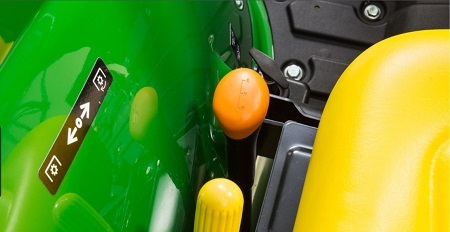 Range lever
Range lever
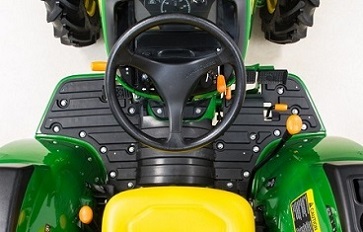 Operator station
Operator station
Key John Deere advantage - A column-mounted forward/reverse lever is a more ergonomic alternative to the floor-mounted design of the competition. Having controls at the operator’s fingertips allows for an effortless change in directions at any time.
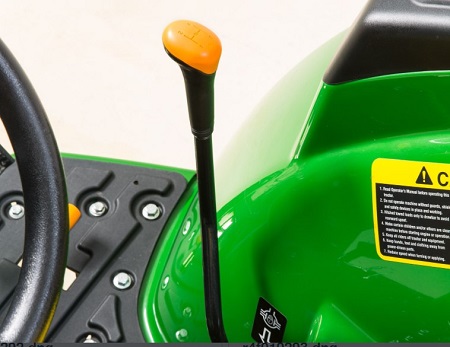 Gear shift lever
Gear shift lever
The 3D is much easier and more comfortable to operate when shifting between gears. The fender-mounted gear shift lever provides the ideal location and placement for the operator’s arm.
Clean and simple operator station is comfortable and convenient
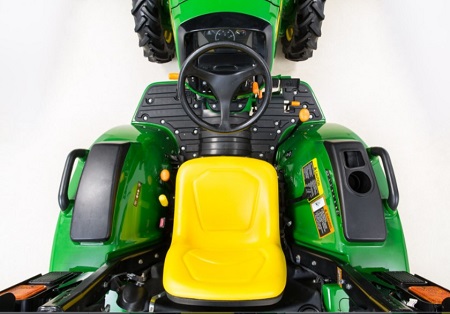 Clean and simple operator's station
Clean and simple operator's station
An uncluttered design gives operators of all sizes plenty of room to be comfortable. Color-coded controls are located on either side of the operator.
- Contoured, comfortable seat enhances operator comfort.
- Seat position adjusts fore and aft
- Seat flips forward for protection from the elements
- Flat operator platform provides for easy entry to/exit from the tractor.
- Folding Roll-Gard™ rollover protective structure (ROPS) and retractable seat belt increase operator safety.
Operator presence system:
- If the operator leaves the seat when the forward/reverse and range lever are in gear, the engine shuts down.
- If the operator leaves the seat when the power take-off (PTO) is engaged, the engine shuts down.
Left-side step
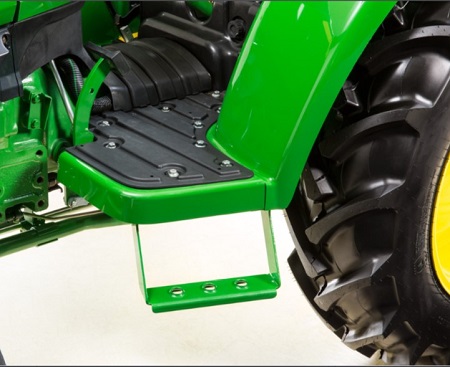 Left-side step for easy entry/exit
Left-side step for easy entry/exit
- The left-side step allows for easy access on and off the tractor.
- Foot platform has a non-skid surface for sure footing.
Seat
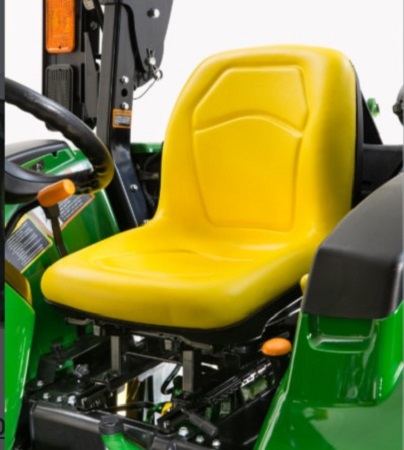 Seat
Seat
The thick, soft padding on this seat provides a smooth and comfortable ride.
- Seat flips forward for protection from the elements.
- Adjustable using the fore and aft lever located under the seat, the seat slides on ramped rails to provide comfortable access to all controls.
Instrumentation
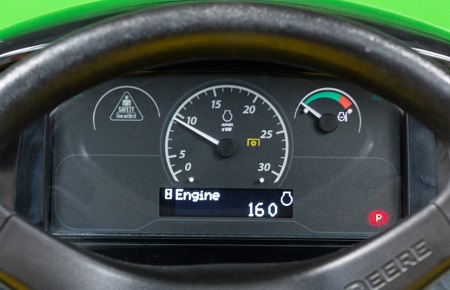 Instrument panel
Instrument panel
Easy-to-read instrument panel includes the following:
- Tachometer
- Low oil pressure indicator light
- Battery discharge indicator light
- PTO engagement indicator light
- Signal/hazard lamp indicator lights
- Multi-function liquid crystal display (LCD) display (hours, filter cleaning information, PTO speed etc.) Filter cleaning status indicator light
Fuel tank and gauge
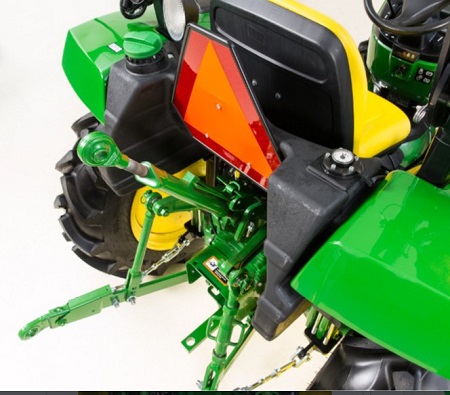 Rear-mounted fuel tank and gauge
Rear-mounted fuel tank and gauge
All 3D Series Tractors come standard with a fuel gauge that is easy to read from the operator's station to ensure operators do not run out of fuel. The fuel tank is also located on the rear of the tractor to allow for easy refill.
Safety
Operator presence switch (OPS) in seat:
- OPS requires the operator to be in the seat to operate the transmission or PTO.
- ROPS is designed to meet or exceed American Society of Agricultural and Biological Engineers (ASABE) safety standards.
- Reflective ROPS strips for better tractor visibility.
- Seat belts are in base equipment on all John Deere compact utility tractors.
- Key switch interlock prevents bypass starting.
- Visual PTO warning light on the instrument panel alerts the operator when the PTO is running.
- Turn signal and flashing warning lights operate according to ASABE standards.
- Slow-moving vehicle (SMV) sign is provided for road transport.
Park brake
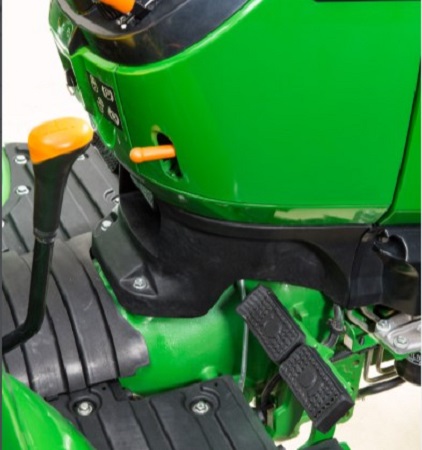 Park brake
Park brake
Instrument panel has an indicator light for the park brake.
Two-post Roll-Gard ROPS
 Roll-Gard ROPS
Roll-Gard ROPS
3D Series Tractors are equipped with Roll-Gard ROPS. These folding ROPS meet the ASABE standards for compact utility tractors.
NOTE: The use of seat belts is recommended at all times when operating the 3D Series Tractor with folding ROPS.
An optional canopy is available to help protect the operator from the elements.
Optional two-spool rear selective control valve (SCV) for superior implement performance
 Optional rear SCVs
Optional rear SCVs
3D Series Tractors can be equipped with a field-installed rear hydraulic remote kit, providing two additional hydraulic spools on the back of the tractor. This kit can be field installed on a tractor with a loader or without a loader.
The functions are completely separate from the loader. These rear remotes can be hooked up to a wide variety of implements and attachments such as follows:
- Hydraulically angled blade
- Hydraulically controlled chute/spout on a 3-point hitch-mounted snow blower
- Hydraulic scarifiers on a box blade
- Many other hydraulic rear attachments
This versatile kit gives 3D Series Tractor operators the options they desire for putting their tractors into a wide range of tasks.
The first spool is equipped with a float position, giving the operator the ability to contour the landscape and improve the final grade with certain implements.
NOTE: Neither of the spools in this kit are equipped with a detent position; therefore, they should not be hooked up to anything with a motor, as the valve was not designed to be run open. The kit is designed for momentary, on-demand hydraulic flow such as moving a cylinder.
The approximate installation time is 1 hour to 1.5 hours.
Optional iMatch™ Quick-Hitch feature allows for easy implement hookup
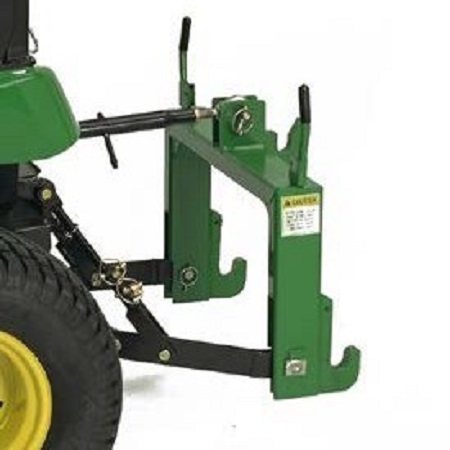 iMatch Quick-Hitch
iMatch Quick-Hitch
 iMatch Quick-Hitch with rotary cutter hookup
iMatch Quick-Hitch with rotary cutter hookup
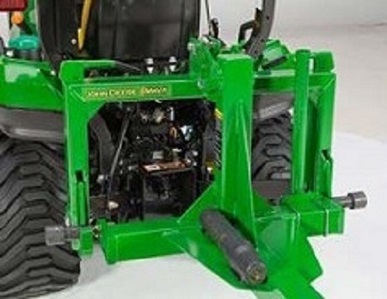 iMatch Quick-Hitch (LVB25976)
iMatch Quick-Hitch (LVB25976)
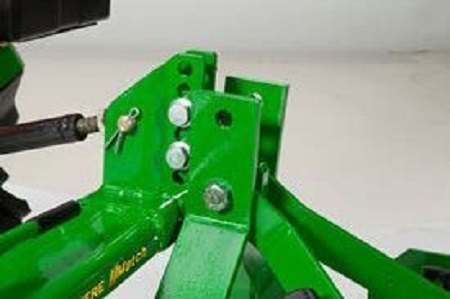 iMatch Quick-Hitch with rotary cutter hookup (LVB25976)
iMatch Quick-Hitch with rotary cutter hookup (LVB25976)
One of the greatest operator concerns involves difficulty in attaching tractor implements. John Deere has addressed this issue with the iMatch Quick-Hitch.
The iMatch Quick-Hitch provides easy hookup and a guaranteed fit for all Category 1 implements that are designed to meet the American Society of Agricultural and Biological Engineers (ASABE) Category 1 Standard S278.6 for quick-attach hitches.
- All implements require a set of bushings in order for the attachment to fit and work properly with the iMatch Quick-Hitch. One set of bushings comes with the iMatch Quick-Hitch.
NOTE: The bushing set can be seen in the picture above. These bushings allow the hooks on the iMatch and the pins on the implement to fit together properly. All other implements (box blades, tillers, rear blades, etc.) will require a set of bushings to enlarge the pin to fit with the iMatch hooks. Bushings of different lengths can be found in the parts system or through a bushing supplier (see dimensions below).
- Upper bushing
- Inside diameter: 1.93-1.95 cm (0.76-0.77 in.)
- Outside diameter: 3.15-3.18 cm (1.24-1.25 in.)
- Lower bushing
- Inside diameter: 2.24-2.26 cm (0.88 to 0.89 in.)
- Outside diameter: 3.63-3.66 cm (1.43 to 1.44 in.)
Excellent serviceability reduces operational costs and improves productivity
Regular service and maintenance are essential to the performance, productivity, and longevity of the tractor.
Easy access to most regular service points minimizes service time.
Tractors are equipped with extensive onboard self-diagnostic capabilities and are fully compatible with the John Deere-exclusive Service ADVISOR™ system.
Hydraulic oil service interval increased to 1200 hours when using Hy-Gard™ products. Hydraulic oil filter will need to be changed every 400 hours.
Fuel tank is located on the rear of the tractor to allow for easy access when fueling.
 Fuel tank on rear of the tractor
Fuel tank on rear of the tractor
- Four quarter turn fasteners allow operators to easily remove the engine side panels to access the engine compartment
 Easy access to engine compartment
Easy access to engine compartment
- Daily service requirements are minimal and simple to accomplish. Most service interval requirements can be performed with a basic understanding of procedures and common tools.
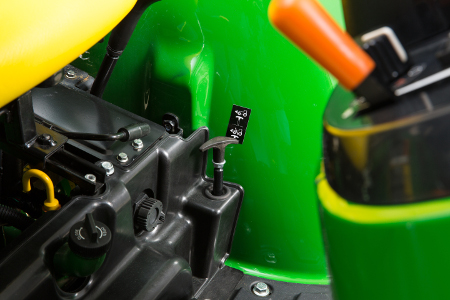 Daily service is quick and easy
Daily service is quick and easy
All items in the daily service schedule can be performed without the use of tools:
Engine oil, hydraulic oil, coolant level, and the water separator can be conveniently accessed.
The engine can be easily accessed by simply raising the hood for more periodic maintenance checks.
NOTE: Always refer to the operator’s manual for complete maintenance and service recommendations.
Features
Clean and simple operator station is comfortable and convenient
 Clean and simple operator's station
Clean and simple operator's station
An uncluttered design gives operators of all sizes plenty of room to be comfortable. Color-coded controls are located on either side of the operator.
- Contoured, comfortable seat enhances operator comfort.
- Seat position adjusts fore and aft
- Seat flips forward for protection from the elements
- Flat operator platform provides for easy entry to/exit from the tractor.
- Folding Roll-Gard™ rollover protective structure (ROPS) and retractable seat belt increase operator safety.
Operator presence system:
- If the operator leaves the seat when the forward/reverse and range lever are in gear, the engine shuts down.
- If the operator leaves the seat when the power take-off (PTO) is engaged, the engine shuts down.
Left-side step
 Left-side step for easy entry/exit
Left-side step for easy entry/exit
- The left-side step allows for easy access on and off the tractor.
- Foot platform has a non-skid surface for sure footing.
Seat
 Seat
Seat
The thick, soft padding on this seat provides a smooth and comfortable ride.
- Seat flips forward for protection from the elements.
- Adjustable using the fore and aft lever located under the seat, the seat slides on ramped rails to provide comfortable access to all controls.
Instrumentation
 Instrument panel
Instrument panel
Easy-to-read instrument panel includes the following:
- Tachometer
- Low oil pressure indicator light
- Battery discharge indicator light
- PTO engagement indicator light
- Signal/hazard lamp indicator lights
- Multi-function liquid crystal display (LCD) display (hours, filter cleaning information, PTO speed etc.) Filter cleaning status indicator light
Fuel tank and gauge
 Rear-mounted fuel tank and gauge
Rear-mounted fuel tank and gauge
All 3D Series Tractors come standard with a fuel gauge that is easy to read from the operator's station to ensure operators do not run out of fuel. The fuel tank is also located on the rear of the tractor to allow for easy refill.
Safety
Operator presence switch (OPS) in seat:
- OPS requires the operator to be in the seat to operate the transmission or PTO.
- ROPS is designed to meet or exceed American Society of Agricultural and Biological Engineers (ASABE) safety standards.
- Reflective ROPS strips for better tractor visibility.
- Seat belts are in base equipment on all John Deere compact utility tractors.
- Key switch interlock prevents bypass starting.
- Visual PTO warning light on the instrument panel alerts the operator when the PTO is running.
- Turn signal and flashing warning lights operate according to ASABE standards.
- Slow-moving vehicle (SMV) sign is provided for road transport.
Park brake
 Park brake
Park brake
Instrument panel has an indicator light for the park brake.
Two-post Roll-Gard ROPS
 Roll-Gard ROPS
Roll-Gard ROPS
3D Series Tractors are equipped with Roll-Gard ROPS. These folding ROPS meet the ASABE standards for compact utility tractors.
NOTE: The use of seat belts is recommended at all times when operating the 3D Series Tractor with folding ROPS.
An optional canopy is available to help protect the operator from the elements.
Optional two-spool rear selective control valve (SCV) for superior implement performance
 Optional rear SCVs
Optional rear SCVs
3D Series Tractors can be equipped with a field-installed rear hydraulic remote kit, providing two additional hydraulic spools on the back of the tractor. This kit can be field installed on a tractor with a loader or without a loader.
The functions are completely separate from the loader. These rear remotes can be hooked up to a wide variety of implements and attachments such as follows:
- Hydraulically angled blade
- Hydraulically controlled chute/spout on a 3-point hitch-mounted snow blower
- Hydraulic scarifiers on a box blade
- Many other hydraulic rear attachments
This versatile kit gives 3D Series Tractor operators the options they desire for putting their tractors into a wide range of tasks.
The first spool is equipped with a float position, giving the operator the ability to contour the landscape and improve the final grade with certain implements.
NOTE: Neither of the spools in this kit are equipped with a detent position; therefore, they should not be hooked up to anything with a motor, as the valve was not designed to be run open. The kit is designed for momentary, on-demand hydraulic flow such as moving a cylinder.
The approximate installation time is 1 hour to 1.5 hours.
Optional iMatch™ Quick-Hitch feature allows for easy implement hookup
 iMatch Quick-Hitch
iMatch Quick-Hitch
 iMatch Quick-Hitch with rotary cutter hookup
iMatch Quick-Hitch with rotary cutter hookup
 iMatch Quick-Hitch (LVB25976)
iMatch Quick-Hitch (LVB25976)
 iMatch Quick-Hitch with rotary cutter hookup (LVB25976)
iMatch Quick-Hitch with rotary cutter hookup (LVB25976)
One of the greatest operator concerns involves difficulty in attaching tractor implements. John Deere has addressed this issue with the iMatch Quick-Hitch.
The iMatch Quick-Hitch provides easy hookup and a guaranteed fit for all Category 1 implements that are designed to meet the American Society of Agricultural and Biological Engineers (ASABE) Category 1 Standard S278.6 for quick-attach hitches.
- All implements require a set of bushings in order for the attachment to fit and work properly with the iMatch Quick-Hitch. One set of bushings comes with the iMatch Quick-Hitch.
NOTE: The bushing set can be seen in the picture above. These bushings allow the hooks on the iMatch and the pins on the implement to fit together properly. All other implements (box blades, tillers, rear blades, etc.) will require a set of bushings to enlarge the pin to fit with the iMatch hooks. Bushings of different lengths can be found in the parts system or through a bushing supplier (see dimensions below).
- Upper bushing
- Inside diameter: 1.93-1.95 cm (0.76-0.77 in.)
- Outside diameter: 3.15-3.18 cm (1.24-1.25 in.)
- Lower bushing
- Inside diameter: 2.24-2.26 cm (0.88 to 0.89 in.)
- Outside diameter: 3.63-3.66 cm (1.43 to 1.44 in.)
Excellent serviceability reduces operational costs and improves productivity
Regular service and maintenance are essential to the performance, productivity, and longevity of the tractor.
Easy access to most regular service points minimizes service time.
Tractors are equipped with extensive onboard self-diagnostic capabilities and are fully compatible with the John Deere-exclusive Service ADVISOR™ system.
Hydraulic oil service interval increased to 1200 hours when using Hy-Gard™ products. Hydraulic oil filter will need to be changed every 400 hours.
Fuel tank is located on the rear of the tractor to allow for easy access when fueling.
 Fuel tank on rear of the tractor
Fuel tank on rear of the tractor
- Four quarter turn fasteners allow operators to easily remove the engine side panels to access the engine compartment
 Easy access to engine compartment
Easy access to engine compartment
- Daily service requirements are minimal and simple to accomplish. Most service interval requirements can be performed with a basic understanding of procedures and common tools.
 Daily service is quick and easy
Daily service is quick and easy
All items in the daily service schedule can be performed without the use of tools:
Engine oil, hydraulic oil, coolant level, and the water separator can be conveniently accessed.
The engine can be easily accessed by simply raising the hood for more periodic maintenance checks.
NOTE: Always refer to the operator’s manual for complete maintenance and service recommendations.
Features
Reliable gear-driven transmission provides optimum tractor performance
The 3D Tractors are available with a gear drive transmission with eight speeds in both forward and reverse directions . It includes a drivetrain built with heavy-duty components, similar to those used in some John Deere utility tractors. These components ensure a rugged and durable machine.
- The spiral bevel gear of the 3D machine is larger in diameter than comparable tractors.
Column-mounted forward and reverse lever for increased efficiency and comfort when changing directions.
Fender-mounted gear shift lever for more comfortable shifting
Safety features of the 3D Series Tractors include:
The tractor will only start with the forward/reverse and range levers in neutral.
The engine will shut off if the operator leaves the seat unless the forward/reverse and range levers are in neutral.
The engine will shut off if the operator leaves the seat and the power take-off (PTO) is engaged.
Ergonomic and optimized shift levers
 Forward/reverse lever
Forward/reverse lever
 Range lever
Range lever
 Operator station
Operator station
Key John Deere advantage - A column-mounted forward/reverse lever is a more ergonomic alternative to the floor-mounted design of the competition. Having controls at the operator’s fingertips allows for an effortless change in directions at any time.
 Gear shift lever
Gear shift lever
The 3D is much easier and more comfortable to operate when shifting between gears. The fender-mounted gear shift lever provides the ideal location and placement for the operator’s arm.
Clean and simple operator station is comfortable and convenient
 Clean and simple operator's station
Clean and simple operator's station
An uncluttered design gives operators of all sizes plenty of room to be comfortable. Color-coded controls are located on either side of the operator.
- Contoured, comfortable seat enhances operator comfort.
- Seat position adjusts fore and aft
- Seat flips forward for protection from the elements
- Flat operator platform provides for easy entry to/exit from the tractor.
- Folding Roll-Gard™ rollover protective structure (ROPS) and retractable seat belt increase operator safety.
Operator presence system:
- If the operator leaves the seat when the forward/reverse and range lever are in gear, the engine shuts down.
- If the operator leaves the seat when the power take-off (PTO) is engaged, the engine shuts down.
Left-side step
 Left-side step for easy entry/exit
Left-side step for easy entry/exit
- The left-side step allows for easy access on and off the tractor.
- Foot platform has a non-skid surface for sure footing.
Seat
 Seat
Seat
The thick, soft padding on this seat provides a smooth and comfortable ride.
- Seat flips forward for protection from the elements.
- Adjustable using the fore and aft lever located under the seat, the seat slides on ramped rails to provide comfortable access to all controls.
Instrumentation
 Instrument panel
Instrument panel
Easy-to-read instrument panel includes the following:
- Tachometer
- Low oil pressure indicator light
- Battery discharge indicator light
- PTO engagement indicator light
- Signal/hazard lamp indicator lights
- Multi-function liquid crystal display (LCD) display (hours, filter cleaning information, PTO speed etc.) Filter cleaning status indicator light
Fuel tank and gauge
 Rear-mounted fuel tank and gauge
Rear-mounted fuel tank and gauge
All 3D Series Tractors come standard with a fuel gauge that is easy to read from the operator's station to ensure operators do not run out of fuel. The fuel tank is also located on the rear of the tractor to allow for easy refill.
Safety
Operator presence switch (OPS) in seat:
- OPS requires the operator to be in the seat to operate the transmission or PTO.
- ROPS is designed to meet or exceed American Society of Agricultural and Biological Engineers (ASABE) safety standards.
- Reflective ROPS strips for better tractor visibility.
- Seat belts are in base equipment on all John Deere compact utility tractors.
- Key switch interlock prevents bypass starting.
- Visual PTO warning light on the instrument panel alerts the operator when the PTO is running.
- Turn signal and flashing warning lights operate according to ASABE standards.
- Slow-moving vehicle (SMV) sign is provided for road transport.
Park brake
 Park brake
Park brake
Instrument panel has an indicator light for the park brake.
Two-post Roll-Gard ROPS
 Roll-Gard ROPS
Roll-Gard ROPS
3D Series Tractors are equipped with Roll-Gard ROPS. These folding ROPS meet the ASABE standards for compact utility tractors.
NOTE: The use of seat belts is recommended at all times when operating the 3D Series Tractor with folding ROPS.
An optional canopy is available to help protect the operator from the elements.
Optional two-spool rear selective control valve (SCV) for superior implement performance
 Optional rear SCVs
Optional rear SCVs
3D Series Tractors can be equipped with a field-installed rear hydraulic remote kit, providing two additional hydraulic spools on the back of the tractor. This kit can be field installed on a tractor with a loader or without a loader.
The functions are completely separate from the loader. These rear remotes can be hooked up to a wide variety of implements and attachments such as follows:
- Hydraulically angled blade
- Hydraulically controlled chute/spout on a 3-point hitch-mounted snow blower
- Hydraulic scarifiers on a box blade
- Many other hydraulic rear attachments
This versatile kit gives 3D Series Tractor operators the options they desire for putting their tractors into a wide range of tasks.
The first spool is equipped with a float position, giving the operator the ability to contour the landscape and improve the final grade with certain implements.
NOTE: Neither of the spools in this kit are equipped with a detent position; therefore, they should not be hooked up to anything with a motor, as the valve was not designed to be run open. The kit is designed for momentary, on-demand hydraulic flow such as moving a cylinder.
The approximate installation time is 1 hour to 1.5 hours.
Optional iMatch™ Quick-Hitch feature allows for easy implement hookup
 iMatch Quick-Hitch
iMatch Quick-Hitch
 iMatch Quick-Hitch with rotary cutter hookup
iMatch Quick-Hitch with rotary cutter hookup
 iMatch Quick-Hitch (LVB25976)
iMatch Quick-Hitch (LVB25976)
 iMatch Quick-Hitch with rotary cutter hookup (LVB25976)
iMatch Quick-Hitch with rotary cutter hookup (LVB25976)
One of the greatest operator concerns involves difficulty in attaching tractor implements. John Deere has addressed this issue with the iMatch Quick-Hitch.
The iMatch Quick-Hitch provides easy hookup and a guaranteed fit for all Category 1 implements that are designed to meet the American Society of Agricultural and Biological Engineers (ASABE) Category 1 Standard S278.6 for quick-attach hitches.
- All implements require a set of bushings in order for the attachment to fit and work properly with the iMatch Quick-Hitch. One set of bushings comes with the iMatch Quick-Hitch.
NOTE: The bushing set can be seen in the picture above. These bushings allow the hooks on the iMatch and the pins on the implement to fit together properly. All other implements (box blades, tillers, rear blades, etc.) will require a set of bushings to enlarge the pin to fit with the iMatch hooks. Bushings of different lengths can be found in the parts system or through a bushing supplier (see dimensions below).
- Upper bushing
- Inside diameter: 1.93-1.95 cm (0.76-0.77 in.)
- Outside diameter: 3.15-3.18 cm (1.24-1.25 in.)
- Lower bushing
- Inside diameter: 2.24-2.26 cm (0.88 to 0.89 in.)
- Outside diameter: 3.63-3.66 cm (1.43 to 1.44 in.)
Excellent serviceability reduces operational costs and improves productivity
Regular service and maintenance are essential to the performance, productivity, and longevity of the tractor.
Easy access to most regular service points minimizes service time.
Tractors are equipped with extensive onboard self-diagnostic capabilities and are fully compatible with the John Deere-exclusive Service ADVISOR™ system.
Hydraulic oil service interval increased to 1200 hours when using Hy-Gard™ products. Hydraulic oil filter will need to be changed every 400 hours.
Fuel tank is located on the rear of the tractor to allow for easy access when fueling.
 Fuel tank on rear of the tractor
Fuel tank on rear of the tractor
- Four quarter turn fasteners allow operators to easily remove the engine side panels to access the engine compartment
 Easy access to engine compartment
Easy access to engine compartment
- Daily service requirements are minimal and simple to accomplish. Most service interval requirements can be performed with a basic understanding of procedures and common tools.
 Daily service is quick and easy
Daily service is quick and easy
All items in the daily service schedule can be performed without the use of tools:
Engine oil, hydraulic oil, coolant level, and the water separator can be conveniently accessed.
The engine can be easily accessed by simply raising the hood for more periodic maintenance checks.
NOTE: Always refer to the operator’s manual for complete maintenance and service recommendations.
Features
Cummins® X15 (15-L [912 cu in] displacement) engine
 9RT engine
9RT engine
 9RT with Cummins X15 15.0L engine
9RT with Cummins X15 15.0L engine
John Deere and Cummins have partnered to provide customers with a reliable, productive and efficient engine solution in the X15. Extensive work has been done between John Deere and Cummins on software development and other engine/tractor application interface points to provide producers with the performance and efficiency they have come to expect from John Deere.
The X15 has followed the same building block approach to meet emissions requirements as similar John Deere engines. This allows John Deere to provide common technologies to producers throughout different horsepower and engine displacement offerings ensuring a consistent experience for producers. Just like the other two engine offerings in the 9 Family of tractors, the X15 features exhaust gas recirculation (EGR) and an exhaust aftertreatment combination of a diesel particulate filter (DPF) and selective catalytic reduction (SCR) to meet the near-zero NOx and particulate matter (PM) emissions standards.
X15 technology
XPI fuel system – the XPI common-rail fuel system delivers a precise quantity of fuel at ultra-high pressures. This, together with electronic engine controls, enables multiple injection events per cycle. Flexibility in injection timing increases fuel economy and performance while decreasing exhaust emissions.
VGT turbocharger – the X15 utilizes a single Cummins VGT™ turbocharger which features electric actuation for infinite adjustment.
Cooled EGR –system has been rebalanced for use with SCR, reducing flow volume and minimizing diesel exhaust fluid (DEF) consumption levels.
Fully integrated electronic controls – a single electronic control module (ECM) controls everything from air intake to exhaust aftertreatment.
Cummins particulate filter and SCR – Cummins particulate filter operates as a nearly passive device, with minimal regeneration required.
Cummins and VGT are a trademarks of Cummins Inc.
Standard CommandView™ III cab offers unsurpassed amenities
 CommandView III cab
CommandView III cab
The standard CommandView III cab offers unsurpassed visibility, operator comfort, control placement, and ride and sound quality.
Features:
- ComfortCommand™ seat with air suspension, lumbar support, swivel, fore-aft and lateral attenuation, backrest angle adjustment, adjustable left-hand armrest, and 40-degree right-hand seat swivel
- Operator presence system that warns if the operator is out of the seat while operating key functions
- Folding instructional seat
- CommandARM™ control center with integrated controls
- 4100 or 4600 Generation 4 CommandCenter™ processor
- Behind-the-seat storage
- Left-hand storage compartment
- Passive noise reduction system
- Service ADVISOR™ diagnostic system data port
- Tilt/telescoping steering wheel with position memory
- Swing-out rear window, opens 30 degrees
- Right- and left-outside mirrors (manually adjustable mirror head)
- Monitor mounts on right-hand front post and rear cab post
- Standard radio package, including AM/FM stereo and weatherband with remote controls, auxiliary input jack, four speakers, and an external antenna
- Laminated glass
- Air conditioner and heater with automatic temperature controls (ATC)
- Two 12-V convenience outlet (cigarette lighter style)
- One 12-V 3-pin outlet with adapter (provides switched and unswitched power)
- One International Organization for Standardization (ISO) nine-pin connector
- Power strip with convenience plug adapter
- Hitch control lever lock and selective control lever lock
- Two-speed and intermittent front and rear wiper with washer
- Front pull-down sunshade
- Digital cornerpost display with:
- Fuel level gauge, including low fuel warning
- Temperature gauge
- Diesel exhaust fluid (DEF) gauge, including low DEF warning
- Engine rpm
- Transmission commanded gear or speed
- Vehicle system functions, such as iTEC™ end-row guidance, that are operating
- Inside-mounted rearview mirror
- Beverage holders sized to accommodate various containers
- Interior left-hand dome light
ComfortCommand seat
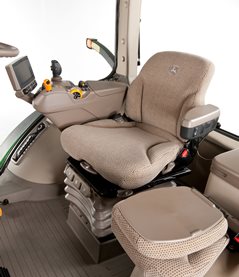 ComfortCommand seat
ComfortCommand seat
ComfortCommand seat improves ride quality and helps to reduce operator fatigue
Features include:
- Armrests, lumbar support, and backrest angle are easily adjusted to match operator preference.
- Shock absorbers dampen the motion effect of the tractor for an improved ride.
- Seat height adjustments are conveniently located on the left armrest.
- Fore-aft adjustment is easy to reach located on the left front of the seat.
- Swivel adjustment, located on the front of the seat, allows the seat to be swiveled 40 degrees to the right or eight degrees to the left of the center position.
- Operator presence switch warns if the operator is out of the seat while operating key functions.
- Seat belt retractor.
- Centered cab seat, providing excellent over-shoulder visibility.
- Adjustable shock absorber permitting ride adjustment from soft to firm to match the operator's desired comfort level.
- Removable cushions for easy cleaning.
CommandARM
 CommandARM controls
CommandARM controls
John Deere 9 Family Tractors feature the CommandARM with integrated Generation 4 CommandCenter display. The control layout of the CommandARM utilizes a clean and efficient design which groups controls by function and builds upon John Deere’s history of intuitive and ergonomic control placement and operation. The design of the CommandARM allows for a 40-degree right seat swivel and adjustable positioning matching the operator’s preference.
Controls located on the CommandARM include:
- Engine throttle
- Transmission control for e18™ transmission speed PowerShift™ transmission
- Eco mode (minimum engine speed) for e18 speed PowerShift transmission
- FieldCruise™ engine controls
- Selective control valve (SCV) controls
- AutoLoad™ controls (if equipped)
- Differential lock on/off and automatic
- iTEC™ sequence switches
- AutoTrac™ assisted steering system resume switch (if equipped)
- Radio
- Beacon light on/off
- Hazard lights on/off
- Field lights 1/2
- Heating, ventilation, air-conditioning (HVAC) system
Hydraulic controls
Hydraulic controls utilize fingertip paddle pots for raise/lower and extend/retract functions.
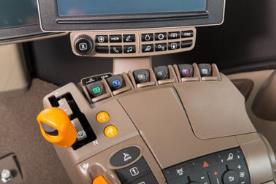 Fingertip paddle pots
Fingertip paddle pots
Throttle
The throttle design incorporates buttons which control FieldCruise speed, and transmission eco settings.
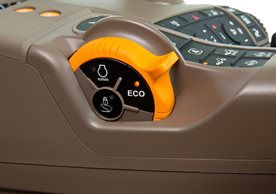 Throttle
Throttle
Tractor function controls
Located just to the right of the throttle is the Auto-Trac activation button and four sequence controls for iTEC functions. Behind the iTEC sequence controls there are buttons which control the activation and deactivation of differential lock. Differential lock can also be activated by the foot switch on the cab floor.
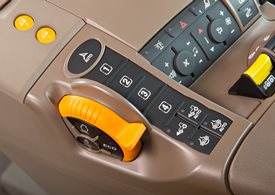 AutoTrac resume and iTEC strip
AutoTrac resume and iTEC strip
Controls for radio, lights, rotary beacon (if equipped), hazard flashers, and HVAC system are located to the center-right on the CommandARM, along with power take-off (PTO) for rear PTO.
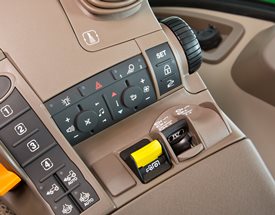 Radio, HVAC, hazard flashers, and PTO controls
Radio, HVAC, hazard flashers, and PTO controls
Seat swivel
The design of the CommandARM allows for up to 40 degrees of right-hand seat swivel.
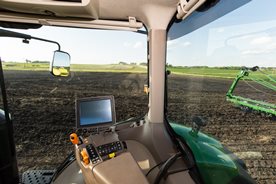 Seat swivel
Seat swivel
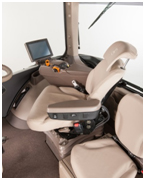 40-degree seat swivel shown
40-degree seat swivel shown
CommandCenter
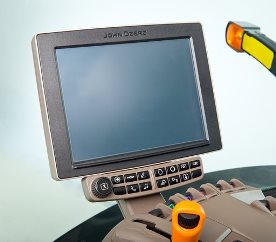 Generation 4 CommandCenter
Generation 4 CommandCenter
The Generation 4 CommandCenters features fast adjustment of tractor functions and controls and are integrated into the CommandARM to create a seamless control center.
The following functions can be adjusted and accessed using the CommandCenter display:
- Hydraulic settings
- Hitch settings
- Transmission settings
- FieldCruise
- iTEC programming functions
- Radio
- Lights
- Add all functionality – diagnostics, display settings, etc.
The Generation 4 CommandCenter systems have the capability of Remote Display Access (RDA). RDA allows improved communication between an offsite farm manager or dealer and the equipment operator. The user can view exactly what the operator sees on the GreenStar™ 3 2630 Display and Generation 4 CommandCenter from almost any internet-connected device. RDA is available on the 4600 and 4100 CommandCenter and allows for an increase in productivity with quicker problem resolution. By using RDA, the cost of operation will decrease due to reduced labor and travel costs, and maximum efficiency will increase profit.
9R/9RT e18™ with Efficiency Manager™
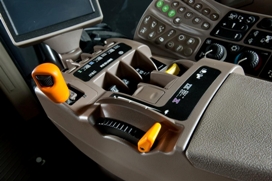 Efficiency Manager thumbwheel
Efficiency Manager thumbwheel
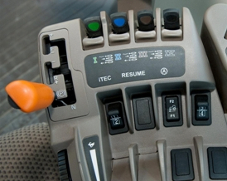 Efficiency Manager switch
Efficiency Manager switch
What is it?
Efficiency Manager allows for IVT™-like operation on the 18-speed PowerShift transmission. With Efficiency Manager engaged, the operator no longer has to manage the engine revolutions per minutes (rpm) and gear selection for the most efficient level of operation possible. Efficiency Manager does that automatically by shifting up and throttling back depending on the load on the tractor.
How does it work?
With the tractor sitting still, in neutral, or once the tractor is in motion, the operator simply pushes either the F1 or F2 switch on the CommandARM™ to activate the feature. Once Efficiency Manager is activated, the operator can set and adjust the desired ground speed by using the thumbwheel on the shift lever. An icon and the desired ground speed will appear on the corner post display once Efficiency Manager is activated.
The operator can program two ground speeds by pushing either the F1 or F2 switch. The F1 setting will typically be set for field work while the F2 setting will be used for field/road transport. F1 can be set at any speed from 2 mph (3.2 km/h) to 12.6 (20.3 km/h) mph, and F2 can be set at any speed from 2 mph (3.2 km/h) to 25 mph (40 km/h).
Can it be managed by the operator?
By navigating through the CommandCenter™, the operator can adjust the rpm shift points while operating in custom mode. The operator can set it to automatic or custom. In automatic mode, the tractor will predict the optimum shift points under load to maintain the highest level of performance and operation. Custom mode allows the operator to adjust how high or low he/she would like the engine rpm to pull down before shifting under load. See the operator’s manual for more information.
Operation example:
If a customer is operating a 9R, equipped with the 18-speed PowerShift transmission, on a grain cart he/she could set F1 to the same speed as the combine for an unload, on the go scenario. Once the combine is empty and the 9R operator is ready to unload the grain from the cart onto the truck, he/she could push the F2 switch (already set at a higher transport speed) to get them to the truck quicker.
NOTE: Efficiency Manager is not recommended during for use during high draft load applications. We do not recommend the use of EM during the cut cycle in scraper applications. Efficiency Manager is recommended during the transport cycle of scraper applications.
JDLink™ services and Service ADVISOR™ diagnostic systems
JDLink
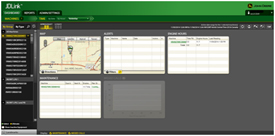 JDLink Dashboard
JDLink Dashboard
JDLink is the John Deere telematics system designed for operators and managers who desire to take their operations to the next level of productivity and efficiency without leaving the office. Whether it is receiving an e-mail or text message, users can manage the operation in real-time without being in the cab. Using the power of JDLink can optimize productivity, increase uptime, and boost profits with JDLink information all accessible from a laptop, desktop, or mobile device.
JDLink Ultimate provides enhanced machine performance and utilization information that can only be achieved through direct communication with on-board machine controllers. Utilizing John Deere-exclusive telematics technology, users can remotely link to Ultimate-compatible machines to achieve a new level of optimization.
NOTE: Mobile device compatibility and functionality varies.
Monitor assets, performance, and more with JDLink:
- Increase uptime and reduce time spent managing equipment with JDLink Ultimate
- Coordinate machine and labor logistics
- Unleash new possibilities with wireless machine connectivity
- Locate machines on-the-go with the JDLink app for iPhone®, iPad® or Android™ devices
- Leverage common components from the JDLink system to enable remote support and machine monitoring
- Industry-exclusive Service ADVISOR Remote with JDLink (Canada link)
For more information on JDLink activations and subscriptions, visit www.StellarSupport.com.
NOTE: JDLink is not available in all geographic regions.
Service ADVISOR
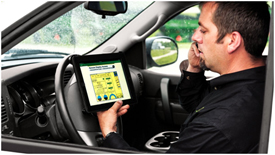 Service ADVISOR
Service ADVISOR
Service ADVISOR diagnostics greatly assist in reducing service costs and downtime. It allows the John Deere service technician to readily extract vital information about tractor malfunctions through the Service ADVISOR data port. Diagnostic codes and controller area network (CAN) bus statistics stored by the tractor and visible in the CommandCenter™ display are used by service technicians to isolate, identify, and resolve problems.
Diagnostics and CAN bus statistics are not normally used by the operator. Access and use of trouble codes should only be done by a qualified, factory-trained John Deere service technician.
Service ADVISOR Remote
Service ADVISOR Remote takes the machine connectivity of JDLink and takes it one step further. With Service ADVISOR Remote, machines can be diagnosed remotely, saving the cost of a field service call. For example, diagnostic trouble codes can be reset and software updates can be uploaded remotely.
Apple, iPhone, and iPad are trademarks of Apple Inc. Android is a trademark of Google LLC.
Power take-off (PTO), 1-3/4 1000 rpm
 PTO and shield
PTO and shield
Fully independent 1000-rpm PTO is available as a factory- or field-installed option.
- Available on all 9 Family Ag Tractors.
- 4.45-cm (1-3/4-in.) diameter shaft.
9R – When the PTO is on and ground speed is 0.5km/h (0.31 mph) or less; PTO is limited to 335 hp.
9RT – When the PTO is on and ground speed is 0.5km/h (0.31 mph) or less; PTO is limited to 329 hp.
9RX – When the PTO is on and ground speed is 0.5km/h (0.31 mph) or less; PTO is limited to 335 hp.
See the specs page for model rated PTO horsepower.
The PTO shield has three positions — neutral, up, and down. Use the neutral position when the PTO is connected and ready for use. Use the up position for added clearance when connecting the PTO shaft to the tractor. The down position is used when the PTO is not connected and extra visibility to the drawbar is desired.
Electrohydraulic PTO control
The 9 Family Tractors utilizes an electrohydraulic PTO-engagement switch to activate the optional 1000-rpm PTO.
If PTO option is not installed, a storage compartment is located on the rear of the tractor.
 Rear storage compartment on 9R
Rear storage compartment on 9R
3-point hitch and CommandCenter™ controls boost productivity
3-point hitch
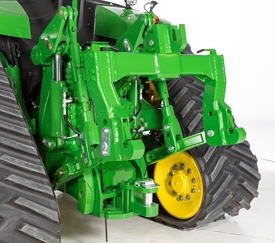 3-point hitch on 9RX
3-point hitch on 9RX
The 9 Family Tractors are designed to maximize performance for different applications. The 9R, 9RT, and 9RX Series Tractors offer two different hitch options:
9370R |
9420R/9420RX |
9470R/9470RT/9470RX |
9520R/9520RT/9520RX |
9570R/9570RT/9570RX |
9620R/9620RX |
|
Category 4N/3 with quik-coupler, all axle diameters |
Optional – 6804 kg (15,000 lb) |
Not available |
||||
Category 4N/3 with quik-coupler, 120-mm (4.7-in.) axles required |
Optional – 9072 kg (20,000 lb) |
Not available |
||||
Category 4/4N with quik-coupler, all diameters axles |
Optional: 6804 kg (15,000 lb) |
|||||
Category 4/4N with quik-coupler, 120-mm (4.7-in.) axle required |
Optional: 9072 kg (20,000 lb) |
|||||
CommandARM™ controls
 Hitch controls
Hitch controls
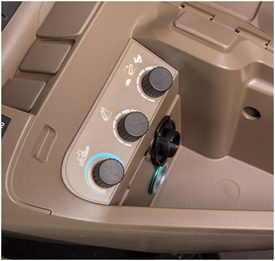 Field-installed 3–point hitch controls under armrest on CommandARM
Field-installed 3–point hitch controls under armrest on CommandARM
To help boost productivity, a field-installed kit with 3-point hitch controls can be purchased. If this option is selected, control buttons will be located on the 9 Family Tractor’s CommmandARM to access individual hitch settings. There are three buttons — set, lock, and load depth. There is also a rotary encoder that allows for finite movements of the hitch. The rotary encoder is detented, so it clicks for each movement. Additionally, hitch adjustment controls are located under the CommandARM for raise/lower rate.
Hitch load depth
The load depth feature is a useful tool designed to increase performance in tillage applications. Load depth adjustments allow the operator to make adjustments to hitch draft responsiveness.
Draft control helps maintain the operating depth in varying conditions, such as rolling terrain, and varying soil densities.
An additional feature with load depth control is the hitch slip option. Hitch slip uses wheel slip data to supplement the draft control system. If the wheels slip, the 3-point hitch lifts to allow the tractor wheels to maintain traction with the ground. Once the slip condition is no longer present, the hitch lowers to the required depth as determined by the hitch command and load depth settings.
Both of these hitch command options are easily programmable in the CommandCenter display by pressing the load depth shortcut key, followed by using the thumbwheel and confirm key to dial in the desired settings.
Hitch, external remote control switch
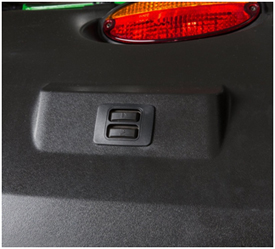 3-point hitch switch on fender of 9R
3-point hitch switch on fender of 9R
For added operator convenience, a 3-point hitch remote control switch is located on top of the left rear fender for 9R, 9RT, and 9RX Tractors. The external remote switches enable the operator to raise and lower the 3-point hitch from behind the tractor while hooking to implements.
High-flow hydraulics, 435-L/min (115-gpm) system
Dual hydraulic pump system
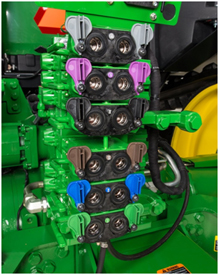 Selective control valve (SCV) stack
Selective control valve (SCV) stack
Optional high-flow hydraulics are available on 9 Family Tractors by ordering code 3270. The high-flow hydraulic system provides an additional 215 L/min (57 gpm) of flow for a total of 435 L/min (115 gpm). This system is ideal for hydraulic fan motor demands. This system is recommended for agricultural implements with continuous flow requirements. When maximum hydraulic pump capacity is reached, multiple functions will continue to operate at the same proportional flow rate.
The 9 Family Ag High-Flow Tractors have two parallel hydraulic systems. The benefit of this system is that functions can be split between the two systems. Functions that require high flow and low pressure can be combined on one system (for example, air seeder fans, and planter motors). Functions that require high pressure and low-flow can be connected to the remaining system (for example, implement lift, fold, and constant down-pressure systems).
Following these guidelines allows the hydraulic system to run cooler as it prevents both hydraulic pumps from running at high pressure. In general, pumps forced to run at both high pressure and high flows generate much more heat than a pump running at a lower flow or lower pressure.
The system operates with two hydraulic pumps:
- Pump 1 - provides hydraulic flow of up to 215 L/min (58 gpm) to SCVs 1, 2, and 3. These SCVs are useful for operating lift/lower and other cylinder type hydraulic needs.
- Pump 2 - attaches in front of pump 1 and provides hydraulic flow of up to 215 L/min (57 gpm) to SCVs 4, 5, and 6. These SCVs are useful for operating hydraulic motors to drive air/fan or vacuum systems on seeding/planting equipment.
- All SCV oil returns to one common hydraulic reservoir.
Eight-section SCV stack for high-flow requirements
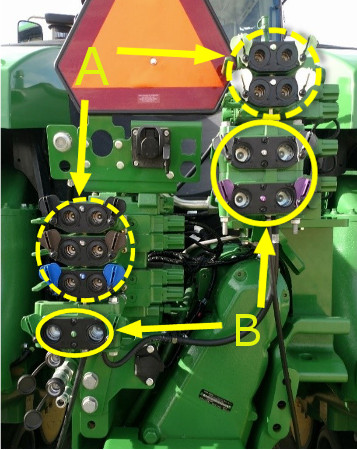 Five 1.3-cm (1/2-in.) couplers (A) and three 1.9-cm (3/4-in.) couplers (B)
Five 1.3-cm (1/2-in.) couplers (A) and three 1.9-cm (3/4-in.) couplers (B)
For applications requiring continuous high hydraulic flow or multiple 1.9-cm (3/4-in.) hydraulic connections, this SCV stack is designed to maximize efficiency of the hydraulic system while providing additional flow using 1.9-cm (3/4-in.) couplers. Arrangement of the 1.9-cm (3/4-in.) couplers are split between the tractor’s dual hydraulic pumps to even the hydraulic load on each pump. Increasing coupler size from 1.3 cm (1/2 in.) to 1.9 cm (3/4 in.) allows an additional 26.5 L/min (7 gpm) or 17 percent more hydraulic flow through each coupler and reduces backpressure for hydraulic functions such as dual fan motors associated with the Air Power™ 2 system equipped on John Deere C850 Air Carts. With three 1.9-cm (3/4-in.) couplers available, operators can connect to other high-demand functions such as raise/lower. The 1.9-cm (3/4-in.) couplers also allow higher fan motor speeds for high-rate applications and allow more power to the ground due to less restriction on the hydraulic system.
NOTE: This SCV configuration is available on all double-reduction) axle 9420R to 9570R Tractors with high-flow hydraulics and all 9RX Tractors with high-flow hydraulics. This eight-section SCV stack does not include hydraulic Intelligent Power Management (IPM) software.
 SCV couplers
SCV couplers
Connections to 1.3-cm (1/2-in.) and 1.9-cm (3/4-in.) couplers are quick and simple for operators with a split SCV stack configuration at a comfortable connection height.
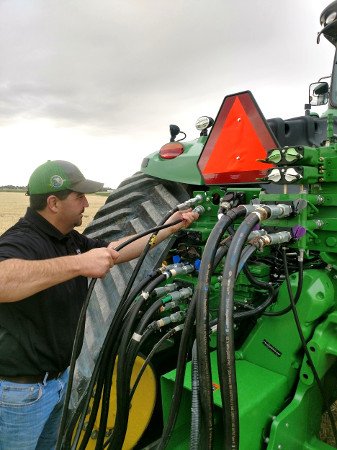 SCV connections in a stack configuration
SCV connections in a stack configuration
General maintenance
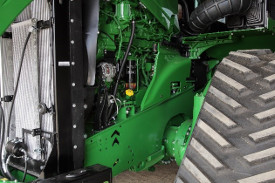 9R, 9RT, and 9RX service access
9R, 9RT, and 9RX service access
Regular service and maintenance are essential to the performance, productivity, and longevity of all farm machinery.
Maximum uptime is an important element of productivity.
- 9 Family service points are quick and simple to check.
- Greater accessibility improves serviceability.
All items in the daily service schedule can be performed without the use of tools:
- Engine oil, hydraulic oil, coolant level, and water separator can be conveniently accessed from ground level without having to open the hood. Engine oil can be checked by simply removing one small engine side panel.
 Engine oil service point
Engine oil service point
- Engine can be easily accessed by simply raising the one-piece hood and removing two engine side panels for more periodic maintenance checks.
- Single-point latch mechanism ensures easy hood opening and closure.
NOTE: Always refer to the operator’s manual for complete maintenance and service recommendations.
Refueling
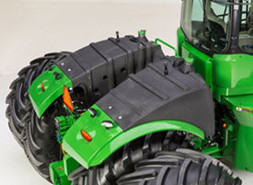 Fuel tank on the 9R
Fuel tank on the 9R
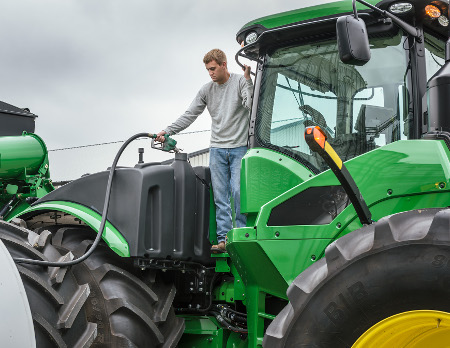 Refueling
Refueling
The 9R Series Tractors fuel tank is located over the rear axle. The fuel tank features a dual fill design. This design allows the machine to be filled from either side of the fuel tank. A fuel nozzle holder is located when the operator positions themselves on the gudgeon platform to fill the fuel tank.
The diesel exhaust fluid (DEF) tank is located on the left-hand side of the tractor indicated by a blue cap. It is fillable from ground level and has a protective shield to keep debris out of the fill neck.
Model |
Diesel |
DEF |
9370R |
1211 L (320 gal.) | 120 L (31.7 gal.) |
9420R |
1514 L (400 gal.)* | 120 L (31.7 gal.) |
9470R |
1514 L (400 gal.)* | 120 L (31.7 gal.) |
9520R |
1514 L (400 gal.) | 120 L (31.7 gal.) |
9570R |
1514 L (400 gal.) | 120 L (31.7 gal.) |
9620R |
1514 L (400 gal.) | 120 L (31.7 gal.) |
*When equipped with double-reduction axle. 1211-L (320-gal.) when equipped with single-reduction axle.
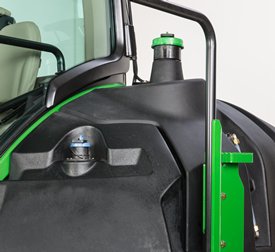 Fuel tank on the left side of 9RT
Fuel tank on the left side of 9RT
The 9RT fuel tank is located behind the cab; the fuel fill is located conveniently on the left-hand main platform.
The 9RT Series Tractors all feature a DEF tank capacity of 93.9 L (24.8 gal.). The fill location is near the diesel fill location.
Model |
Diesel |
DEF |
9470RT |
1325 L (350 gal.) | 93.9 L (24.8 gal.) |
9520RT |
1325 L (350 gal.) | 93.9 L (24.8 gal.) |
9570RT |
1325 L (350 gal.) | 93.9 L (24.8 gal.) |
Model |
Diesel |
DEF |
9470RX |
1514 L (400 gal.) | 120 L (31.7 gal.) |
9520RX |
1514 L (400 gal.) | 120 L (31.7 gal.) |
9570RX |
1514 L (400 gal.) | 120 L (31.7 gal.) |
9620RX |
1514 L (400 gal.) | 120 L (31.7 gal.) |
NOTE:
- John Deere supports the usage of bio diesel. Bio diesel should meet ASTM D6751 (US) or EN 14214 (European) fuel quality standards.
- Tractors receive fuel containing a 2 percent bio-diesel blend at the factory.
- Acceptable blend levels may vary by geographic region.
- Diesel exhaust fluid will freeze when exposed for longer than three hours to conditions below -11°C (12.2° F).
For more information about the use of bio-diesel in John Deere engines, refer to www.JohnDeere.com/biodiesel.
DEF fill
9R, 9RT, and 9RX Series Tractors feature an easy-to-use DEF fill system. The 9R and 9RX feature a ground-level fill location, and DEF fill on 9RT is conveniently located on the step platform.
| Machine | DEF tank capacity |
| 9R | 120 L (31.7 gal.) |
| 9RT | 93.9 L (24.8 gal.) |
| 9RX | 120 L (31.7 gal.) |
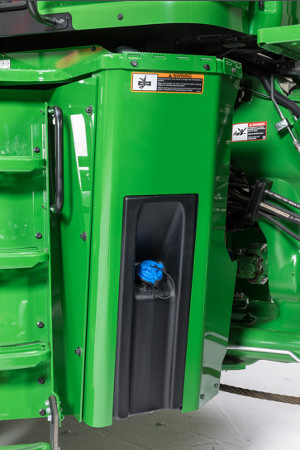 DEF tank on 9R/9RX
DEF tank on 9R/9RX
In-line DEF filter
9R, 9RT, and 9RX Series Tractors feature an in-line DEF filter to help protect the DEF pump from any contamination in the DEF tank. This in-line DEF filter is easily serviced with a drain plug to drain any remaining DEF from the filter housing and a replaceable cartridge-style filter.
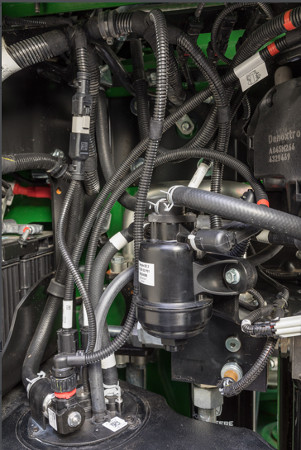 In-line DEF filter
In-line DEF filter
Severe-duty water separator, if equipped
The severe-duty water separator can extend service intervals and helps to protect the tractor’s fuel system from damage associated with lower-quality fuel.
Simply open the drain valve on the bottom of the separator and drain accumulated water.
NOTE: Cummins® QSX 15 L (915.4-cu in.) engines cannot be equipped with a severe-duty water separator; however, the fuel filter has separating capabilities like the primary filter on John Deere Power System engines.
Engine access
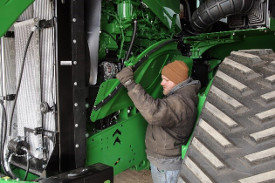 Engine access on 9RX
Engine access on 9RX
The tilt hood and side panel design provides additional engine compartment protection. The 9R, 9RT, and 9RX hoods feature the same design for access to engine components.
Pull out the hood release (located on the front, left side) and tilt hood back to open. Engine side panels are quickly and easily removed for access to periodic maintenance items.
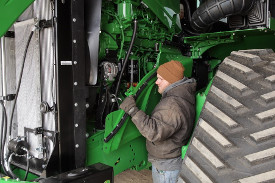 Removing side engine panel
Removing side engine panel
Transmission, hydraulic, and axle oil level
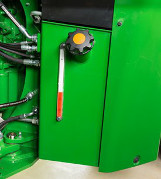 Sight gauge on 9R and 9RX
Sight gauge on 9R and 9RX
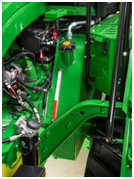 Sight gauge on 9RT
Sight gauge on 9RT
A sight glass for the transmission, hydraulic, and axle oil level is located at the back right side of the gudgeon, indicating proper oil levels, and an oil fill neck is located on the back right side of the gudgeon for the 9R and 9RX Series Tractor. The oil fill is located on the top of the common reservoir on the left side of the 9RT Series Tractor and a fill tube is located between the steps and engine of the tractor.
- Provides increased filter capacity compared to previous 9R and 9RT Series Tractors
- Transmission, hydraulic, and axle oil should be changed every 1500 hours
- Filter should be changed every 1500 hours unless filter restriction code occurs
- Daily and 10-hour inspections of the transmission hydraulic oil level are recommended
NOTE: The tractor should be off and parked on level ground with the hitch in the lowered position when checking the oil level.
- Sight glass observations will be significantly higher with hot oil temperatures and lower with cold oil or if engine has not run long enough.
NOTE: Oil level above the top mark on the sight glass can result in power loss and heat generation during transport applications.
Primary air filter access
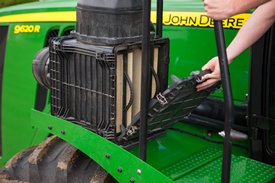 Primary engine air filter inspection
Primary engine air filter inspection
On the 9R and 9RX, the primary engine air filter is accessible from the left-hand platform for replacement annually or as operating conditions require. The filter is aspirated and extends filter life in dusty conditions by aspirating more than 95 percent of incoming dust. Aspirator suction is created by utilizing the air flow from the cooling fan.
On the 9RT, the primary engine air filter is located at ground level on right side of tractor.
Oil change intervals
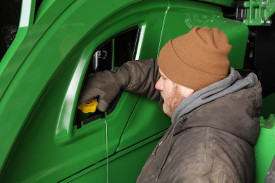 Engine oil check/fill location
Engine oil check/fill location
Tractors with the 9.0L (549.2-cu in.) and 13.5L (823.2-cu in.) John Deere Power Systems engines feature a 500-hour change interval when using approved John Deere Plus-50™ II oil and a John Deere oil filter.
Tractors equipped with the Cummins QSX 15-L (915.4-cu in.) engine have a 400-hour engine oil and oil filter change interval.
- Previous initial oil and filter change at 100 hours is no longer required due to the factory fill of Break-In™ Plus oil.
- If using anything other than John Deere Plus-50 II oil, a 250-hour change interval is required. CJ-4 must still be used.
- Only use ultra-low sulfur diesel fuel and CJ-4, ACEA E9, or ACEA E6 oil.
- An oil change of 500 hours is possible when using fuel with less than 15 parts per million (ppm) of sulfur, along with John Deere Plus-50 II oil.
See the tractor's operator's manual for oil change intervals and further details.
Battery access
 Battery location on 9R and 9RX
Battery location on 9R and 9RX
 Battery location on 9RT
Battery location on 9RT
The 9R and 9RX battery location is behind the left-hand step assembly. There are three bolts that secure the swinging step assembly that need to be removed to completely access the batteries. The 9RT top step of the platform conceals the tractor’s three 12-V batteries with 2775 CCA (925-CCA each). Tractors with the Cummins X15 engine will have four 12-V batteries in the same location as tractors equipped with John Deere Power System engines.
Although the batteries are maintenance free, conditions such as long periods of operation at high ambient temperatures and excessive engine cranking may require adding water.
Battery boost terminal
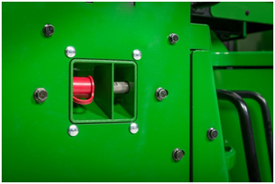 Battery boost terminal
Battery boost terminal
On the 9R and 9RX, a battery boost terminal is located on the left-hand side of the engine for convenient and proper boost assisted starting.
Fuse and relay panel
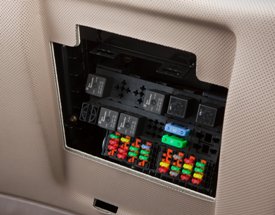 Fuse and relay panel
Fuse and relay panel
The electrical fuse and relay panel is located behind the operator’s seat and just below the cab's rear window. Simply lift up on the operator manual cover for access.
- Contains easy-to-replace automotive blade-type fuses and relays for quick servicing.
- Spare fuses are provided for each amperage size used.
The diode module contains many of the diodes contained in the system:
- If a diode problem occurs, simply replace the diode module for easy service and increased uptime.
- Relays are also fully interchangeable for quick service.
Electrical system (smart load center)
The electrical system provides a full controller area network (CAN) bus based system on the tractor for improved tractor implement integration and flexibility. Incorporated with the system is a smart load center, which provides fewer fuses, fewer connectors, and simplified wiring for increased reliability.
The solid-state load center’s primary function is to control the majority of high-current loads, such as fender floodlights and the horn. This electronic circuitry will monitor loads and voltages to provide fast reaction time and the ability to alert the operator if a circuit overloads or if voltage is out of specification – for example, open circuit (undercurrent) or short circuit (overcurrent).
Cab air filters
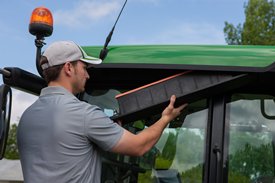 Cab fresh air filter inspection
Cab fresh air filter inspection
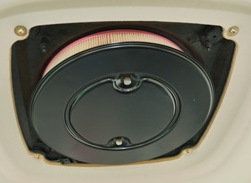 Cab recirculation filter
Cab recirculation filter
The cab fresh air filter is conveniently located beneath the left side of the cab for all 9 Family products:
- External service means no mess in the cab from dusty filters
- Filter housing acts as a dust accumulator compartment
- Hand screw eliminates need for tools
- Replace cab fresh air filter every 1000 hours or sooner if plugged or damaged
Cab air recirculation filter
Cab air recirculation filter is located in the roof liner above the operator. 70 percent of the total air volume is recirculated with a blanket effect for enhanced operator comfort.
- Replace cab air recirculation filter every 1000 hours or sooner if plugged or damaged.
Cab air filters are not designed to filter out harmful chemicals. Follow the instructions in the implement operator’s manual and those given by the chemical manufacturer when using agricultural chemicals.
Windshield washer
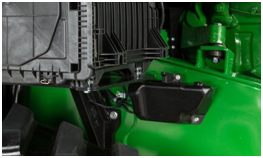 Windshield washer bottle on 9R and 9RX
Windshield washer bottle on 9R and 9RX
The windshield washer bottle is optional on 9R and 9RX Tractors and is located on the left side of the tractor near the DEF fill point. On 9RT Tractors, it is located on the right-side frame.
Maintenance-free U-joint
Maintenance-free U-joint bearings require no servicing to reduce maintenance time.
Toolbox
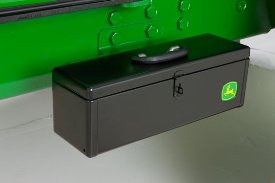 Toolbox for 9R, 9RT and 9RX
Toolbox for 9R, 9RT and 9RX
A convenient toolbox is located on the left-hand side of the front frame for tool storage and comes standard on all 9R, 9RT, and 9RX Series Tractors.
9R and 9RX Series Tractors have an additional storage box conveniently located on top the left-hand platform.
The 9RT has an additional toolbox conveniently located next to the left side of the batteries for additional storage.
Cummins is a trademark of Cummins, Inc.
e18™ PowerShift™ transmission with Efficiency Manager™ feature
The e18 transmission delivers smooth shifting and intuitive controls in a reliable 18-speed PowerShift transmission. The e18 transmission with enhanced Efficiency Manager is standard equipment on all 9 Family Tractors.
The e18 has evolved from more than 50 years of John Deere PowerShift technology. With more automatic features, the e18 is easy to operate for all levels of operators and operations. It features three modes of operation, full AUTO, custom, and manual modes. Full AUTO and custom modes manage the engine and transmission to match the desired ground speed to the field conditions. These two modes are ideal for most conditions and take the guess work out of operation. Manual mode is perfect for operators looking to operate the e18 like a traditional PowerShift by bump shifting and managing the engine throttle to their liking.
As the next generation of PowerShift technology, the e18 delivers the strength to handle sudden, high-torque power loads while maintaining responsive, quick, and smooth shifts.
e18 controls
 Shift lever and hand throttle
Shift lever and hand throttle
CommandCenter™ controls
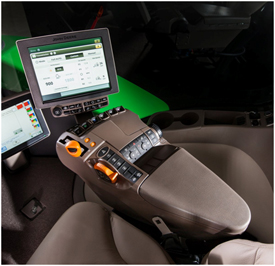 254-mm (10-in.) Generation 4 CommandCenter
254-mm (10-in.) Generation 4 CommandCenter
The CommandCenter is the central information system for tractors and allows the operator to program various settings tailored to a specific operation.
To access the tractor’s transmission settings, press the transmission shortcut button on the CommandCenter shortcut bar.
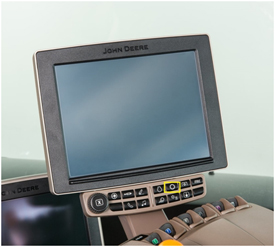 CommandCenter transmission shortcut button
CommandCenter transmission shortcut button
Operating modes
The e18 application settings employ three modes to take full advantage of the engine-transmission communication: Full AUTO mode, custom mode, and manual mode.
Full AUTO mode
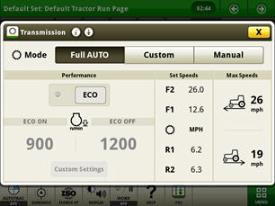 Full AUTO main page
Full AUTO main page
Full AUTO mode manages the tractor’s engine and transmission inputs to reach and maintain the desired ground speed set by the operator. This means the tractor will manage shifts and engine rpm to operate at the most efficient level possible. Operators have the ability to set the maximum forward and reverse speeds for their particular applications. In full AUTO mode the operator can adjust the desired ground speed in two ways, by conducting a traditional bump shift or by rotating the dial on the thumb wheel.
When shifting in full AUTO mode, the transmission shifts set speeds and does not always shift gears, meaning the transmission may not necessarily shift gears if it can reach the desired ground speed with a slightly higher or lower engine rpm. Efficiency Manager is automatically engaged while operating in full AUTO mode. As a result, shifting will not take the tractor out of Efficiency Manager in full AUTO mode.
Custom mode
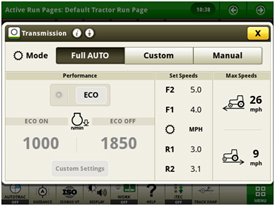 e18 custom transmission page
e18 custom transmission page
Custom mode operates similar to full AUTO mode but allows operators to adjust operating parameters to meet a specific operation. It also has the ability to activate eco mode for a higher level of operation.
 Eco button
Eco button
 Display screen
Display screen
Eco allows two minimum engine speeds to be set. Operators can turn eco on and off by either pushing the eco button on the side of the throttle or by selecting eco in the transmission settings page of the CommandCenter controls. For example, operators may choose to turn eco on during transport to utilize a lower minimum engine speed and then turn eco off while operating in the field where a higher minimum engine speed is desired.
 Custom settings page
Custom settings page
In the advanced settings page, operators can customize the auto shift engine speed droop as a percentage of the full engine speed. In addition, the load anticipation feature can be enabled for the hitch engagement, hydraulic engagement, or both.
Manual mode
Manual mode operates very similarly to a traditional PowerShift transmission with Efficiency Manager.
In manual mode the operator manages the engine and transmission inputs by controlling the shift lever and hand throttle.
 Manual mode page
Manual mode page
Efficiency Manager
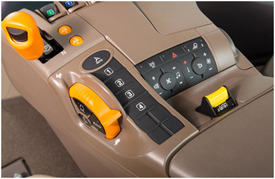 Set speed buttons and set speed adjuster
Set speed buttons and set speed adjuster
Efficiency Manager is automatically enabled in auto and custom modes. Efficiency Manager can be turned on in manual mode by selecting the set speed one or set speed two button on the CommandARM™ console. The set speed adjuster on the top of the single-lever gear selector allows the operator to dial in the desired ground speed to establish set speed one or two. Once engaged, Efficiency Manager will manage the engine rpm and gear selection to maintain the desired working speed. To reach the desired set speed, the throttle must be set to full engine rpm.
e18 operation
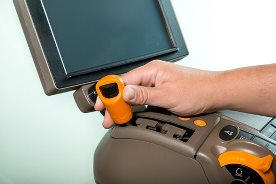 e18 operation
e18 operation
Setting start-up gears
The 9 Family Tractors default to 7F and 2R at start up. However, these default start-up gears can be adjusted from 1-13F and 1-3R through the CommandCenter. Refer to the operator’s manual for additional information.
 Start-up gears in advanced settings
Start-up gears in advanced settings
9R Series Tractor - e18-speed chart for PowerShift transmission with Efficiency Manager
9R table
Group 47 tires |
Group 48 tires |
|||
Tire size |
(480R46, 20.8R42, 520R42, 620R42, 710R38) |
(480R50, 520R46, 620R46, 710R42, 800R38) |
||
Engine (rpm) |
2100 |
2100 |
||
18-speed gear |
km/h |
mph |
km/h |
mph |
Forward gears |
||||
F1 |
4.0 |
2.5 |
4.2 |
2.6 |
F2 |
4.8 |
3.0 |
5.0 |
3.1 |
F3 |
5.3 |
3.3 |
5.6 |
3.5 |
F4 |
5.9 |
3.7 |
6.2 |
3.9 |
F5 |
6.5 |
4.0 |
6.8 |
4.3 |
F6 |
7.3 |
4.5 |
7.6 |
4.8 |
F7 |
8.0 |
5.0 |
8.5 |
5.3 |
F8 |
9.0 |
5.6 |
9.5 |
5.9 |
F9 |
9.9 |
6.1 |
10.4 |
6.5 |
F10 |
11.0 |
6.9 |
11.6 |
7.2 |
F11 |
12.2 |
7.6 |
12.9 |
8.0 |
F12 |
13.5 |
8.4 |
14.2 |
8.8 |
F13 |
15.0 |
9.3 |
15.8 |
9.8 |
F14 |
16.6 |
10.3 |
17.5 |
10.9 |
F15 |
20.5 |
12.8 |
21.6 |
13.4 |
F16 |
25.3 |
15.7 |
26.6 |
16.5 |
F17 |
31.2 |
19.4 |
32.9 |
20.4 |
F18 |
38.5 |
23.9 |
40.5 |
25.2 |
Reverse gears |
||||
R1 |
3.9 |
2.4 |
4.1 |
2.5 |
R2 |
5.3 |
3.3 |
5.6 |
3.5 |
R3 |
5.9 |
3.7 |
6.2 |
3.9 |
R4 |
8.0 |
5.0 |
8.5 |
5.3 |
R5 |
9.0 |
5.6 |
9.5 |
5.9 |
R6 |
12.2 |
7.6 |
12.9 |
8.0 |
Group 47 tire based on 710/70R38
Group 48 tire based on 800/80R38
9RT and 9RX Series Tractor - e18-speed chart for PowerShift transmission with Efficiency Manager
9RT and 9RX table
|
9RT |
9RX |
||
Engine (rpm) |
2100 |
2100 |
||
18-speed gear |
km/h |
mph |
km/h |
mph |
Forward gears |
|
|
|
|
F1 |
4.0 |
2.5 |
4.0 |
2.5 |
F2 |
5.0 |
3.1 |
4.9 |
3.0 |
F3 |
5.5 |
3.4 |
5.5 |
3.4 |
F4 |
6.1 |
3.8 |
6.1 |
3.8 |
F5 |
6.8 |
4.2 |
6.7 |
4.2 |
F6 |
7.6 |
4.7 |
7.5 |
4.7 |
F7 |
8.4 |
5.2 |
8.3 |
5.2 |
F8 |
9.3 |
5.8 |
9.2 |
5.7 |
F9 |
10.3 |
6.4 |
10.2 |
6.3 |
F10 |
11.4 |
7.1 |
11.4 |
7.1 |
F11 |
12.6 |
7.8 |
12.6 |
7.8 |
F12 |
14.1 |
8.7 |
14.0 |
8.7 |
F13 |
15.6 |
9.7 |
15.5 |
9.6 |
F14 |
17.3 |
10.7 |
17.2 |
10.3 |
F15 |
21.4 |
13.3 |
21.3 |
13.2 |
F16 |
26.3 |
16.3 |
26.2 |
16.3 |
F17 |
32.3 |
20.1 |
32.2 |
20.0 |
F18 |
39.8 |
24.7 |
39.6 |
24.6 |
Reverse gears |
|
|
|
|
R1 |
4.0 |
2.5 |
4.0 |
2.5 |
R2 |
5.5 |
3.4 |
5.5 |
3.4 |
R3 |
6.1 |
3.3 |
6.1 |
3.8 |
R4 |
7.3 |
3.8 |
8.3 |
5.2 |
R5 |
9.3 |
5.8 |
9.2 |
5.7 |
R6 |
12.6 |
7.8 |
12.6 |
10.3 |
Features
Mechanical-Front-Wheel Drive
Mechanical-front-wheel drive (MFWD) and differential lock can be engaged on-the-go to give extra traction in poor underfoot conditions or for moving heavy loads. Optional limited-slip front axle delivers 65 percent of available power to the tire with the best traction. For true all-wheel-drive pulling power.
Engine
The 210L EP Interim Tier 4 (IT4)/Stage IIIB emission-certified Yanmar 3.3L engine requires no aftertreatment.
Field-proven technology is simple, fluid efficient, fully integrated, and fully supported. It employs cooled exhaust gas recirculation and selective catalytic reduction.
Eco Mode
Standard economy mode helps maximize fuel usage in lighter-work applications with minimal effect on machine performance.
Ride Control
With ride control activated, front loader hydraulic cylinders act as a shock absorber, smoothing travel over rough terrain, helping full loads reach their destination, and reducing operator fatigue.
Productivity
New hitch design makes it easier to position the box blade over the pile for more versatility and productivity.
Integral three-point hitch accommodates a variety of tools
Operator Comfort
Choose cab or open operator station.
Higher canopy with wider and lower step provides better visibility over the hood and to the corners of the front bucket, as well as to the rear box blade. Makes it easier to service under-canopy components, too.
Easy Maintenance
Two-position tilt hood provides same-side ground-level access to engine and transmission dipsticks, engine-oil fill, fuel and air filters, and coolant reservoir. Fuel fill is also closely convenient.
Features
Mechanical-Front-Wheel Drive
Mechanical-front-wheel drive (MFWD) and differential lock can be engaged on-the-go to give extra traction in poor underfoot conditions or for moving heavy loads. Optional limited-slip front axle delivers 65 percent of available power to the tire with the best traction. For true all-wheel-drive pulling power.
Engine
Rugged FT4/Stage IV PowerTech™ Plus diesel engine employs cooled exhaust gas recirculation and selective catalytic reduction system.
No diesel particulate filter (DPF) is needed on either model, reducing downtime and expense.
Variable-speed electronically controlled fan on the 210L automatically speeds up or slows down, operating only as needed to keep things cool. Helps conserve power and fuel, while reducing noise.
Eco Mode
Standard economy mode helps maximize fuel usage in lighter-work applications with minimal effect on machine performance.
Ride Control
With ride control activated, front loader hydraulic cylinders act as a shock absorber, smoothing travel over rough terrain, helping full loads reach their destination, and reducing operator fatigue.
Productivity
New hitch design makes it easier to position the box blade over the pile for more versatility and productivity.
Integral three-point hitch accommodates a variety of tools.
Operator Comfort
Choose cab or open operator station.
Higher canopy with wider and lower step provides better visibility over the hood and to the corners of the front bucket, as well as to the rear box blade. Makes it easier to service under-canopy components, too.
Easy Maintenance
Two-position tilt hood provides same-side ground-level access to engine and transmission dipsticks, engine-oil fill, fuel and air filters, and coolant reservoir. Fuel fill is also closely convenient.
Features
Engine
Employs cooled exhaust gas recirculation (EGR), easily maintained exhaust filters, and selective catalytic reduction (SCR).
Conserve power and fuel with engine, hydraulic, transmission, and service-brake coolers that run only when necessary. Reversible hydraulic-drive fan option back-blows cooler cores minimizing manual cleaning.
Condition-based ash-service intervals for the diesel particulate filter notify operators before service is required.
Onboard weighing system
Optional onboard weighing system displays the payload while loading and even illuminates mirror-mounted load lights to alert the operator and job superintendent when the ADT is nearing capacity. Load tonnage is also accessible through JDLink™, so you can monitor productivity from virtually anywhere.
The system has been factory calibrated to two-percent accuracy when payload exceeds 50 percent.
Cab Comfort
Sealed and pressurized cab keeps out dust and noise.
Larger entryway allows for easier ingress and egress.
Adjustable air-ride seat provides maximum comfort.
Ground-Level Maintenance
Filters, diagnostic ports and hydraulic oil reservoir are easy to access. An industry-leading feature, Deere machines can be checked and serviced daily from the ground, eliminating the need for tie-offs. This is a big advantage on MSHA regulated sites.
Standard Tire Pressure Monitoring
Standard tire pressure/temperature-monitoring system helps maximum tire life and fuel efficiency. A passive alarm appears on monitor if pressure drops by 10 percent.
Auto-diff lock
Traction-boosting auto-diff lock engages and disengages as necessary, simplifying operation. Or it can be engaged on-the-fly if slipping is occurring.
Safety Features
Safety features include autohorn, industry-leading transmission retarding, and braking performance for steep grade control. Easy-to-activate cab tilt doubles as a remote park-brake release (optional).
Mirror Mounting
All-new mirror mounting increases visibility, reduces vibration, and allows walk-through access to the engine compartment.
Dump Body
High-alloy-steel dump body and chassis deliver superior strength and rigidity without adding weight.
Features
Engine
Our FT4/Stage IV diesels delivers generous displacement, power, and lugging ability.
Ash-service intervals for the diesel particulate filter (DPF) are condition based, so changing it may not be necessary until the first engine overhaul. Intervals can be extended further depending on application, regular maintenance practices, and the use of recommended fluids and lubricants.
Quad-Cool™
Quad-Cool places the radiator, air-conditioner condenser, intercooler, and hydraulic, transmission, and optional axle coolers in a unique boxed configuration that's isolated from engine heat.
Optional programmable fan reverses, ejecting debris from radiator and cooler cores.
Transmission and Axles
With ride control, the lift cylinders act as shock absorbers, cushioning bumps to allow these loaders to navigate rough ground more quickly without losing their loads.
Automatic differential lock engages as soon as a tire begins to slip. It's ideal for inexperienced operators or applications requiring high traction, such as stockpiling silage, plowing snow, and handling pipe.
Maintenance
Lockable compartment swings open wide, offering convenient ground-level access to remote-start battery terminals and the electrical-disconnect switch.
Conveniently located, easy-to-read sight gauges and see-through reservoirs let you check transmission, hydraulic, coolant, and windshield washer fluid levels at a glance.
Controls
Choose single-lever joystick or two-lever fingertip pilot-operated hydraulic controls.
Optional joystick steering is ideal for V-pattern truck loading.
Versatility
Equip your loader with optional Z-Bar, High Lift, Tool Carrier, or Parallel Lift linkage
Worksite Pro couplers make attachment switchover easy to get even more out of your machine.
Safety & Security
Sealed-switch module keeps out dust and moisture while eliminating nearly 100 wires. Prevent unauthorized machine operation with keyless-start requiring a numeric pass code.
Optional rearview camera and radar object-detection system
Features
Engine
The EPA FT4/EU Stage IV engine employs field-proven cooled exhaust gas recirculation (EGR) for reducing NOX, and a diesel particulate filter and diesel oxidation catalyst to reduce particulate matter.
Ash-service intervals for the diesel particulate filter (DPF) are condition based, with the machine notifying the operator before service is required.
Highly efficient hydraulically driven fans run only as fast as needed, reducing noise, fuel consumption, and operating costs. The cooling systems keep things running cool, even in high-trash environments and high altitudes. Reversing option automatically back-blows cooler cores to keep them clean.
Controls
Ergonomically correct short-throw pilot levers provide smooth, predictable fingertip control with less movement and effort.
Push buttons in the right lever allow predictable control of auxiliary hydraulic flow for operating attachments. Optional sliding switch provides proportional speed control.
Press the power-boost button on the right-hand control for extra digging power. Power boost also kicks in automatically in boom-up/lifting functions.
Productivity
Three productivity modes allow you to choose the digging style that fits the job:
- High-productivity delivers more power and faster hydraulic response to move more material.
- Power delivers a balance of power, speed, and fuel economy for normal operation.
- Economy limits top speed and helps save fuel.
Visibility
New hood design, expanded front and side glass, narrow front cab posts, overhead glass, and numerous mirrors provide optimal visibility.
Serviceability
Swing open the side panels and you'll discover many of the numerous ways this excavator can minimize maintenance, increase uptime, and reduce daily operating costs.
Larger hood enables greater access to engine components for easy daily service and the ability to inspect the engine, drive belt, and coolant and oil levels from one location
Arm & Boom
A John Deere exclusive, three welded bulkheads within the boom resist torsional stress for amazing durability.
Features
Engine
Yanmar 3.3L Interim Tier 4 engine complies with EPA FT4 emission regulations. With no aftertreatment components needed, the design minimizes machine complexity and the number of parts that must be maintained by the customer.
PowerShift™ Transmission
Standard John Deere PowerShift™ Transmission provides smooth, on-the-fly, clutch-free gear shifts.
Mechanical Front Wheel Drive
Optional limited slip MFWD delivers superior traction that delivers up to 65% of the available power to the wheel with the best grip. The axle design removes the need for 'breathers', eliminating the potential for contamination by dirt or water.
Cab and Controls
L-Series pilot towers provide more legroom and additional space for transitioning between loader and backhoe operation. Palm-on-top loader-control grip makes operation even easier with integrated electric clutch disconnect.
Ride Control
Optional ride control, front loader hydraulic cylinders act as a shock absorber, smoothing travel over rough terrain.
Easy Maintenance
Same-side, ground-level service points help speed daily checks and fills. Other common-sense features such as quick-change filters, extended service intervals, simple-to-read sight gauges, and easy-access grease zerks help increase uptime and lower daily operating costs.
Security
Machine-security system with touchpad passcode helps prevent unauthorized operation.
Features
Engine is smooth running and reliable V-twin liquid-cooled design
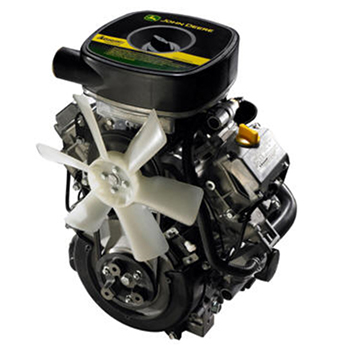 25.5-hp (19-kW) engine
25.5-hp (19-kW) engine
The V-twin, liquid-cooled John Deere iTorque power system with electronic fuel injection (EFI) provides exceptional performance and has the durability to handle commercial-use applications. The John Deere iTorque power system includes a combination of engine features that provide more lugging ability, even cooling, and durability.
iTorque stands for intelligent design (to get a task done efficiently) and torque (good lugging ability). It is used exclusively on gasoline-powered Select Series™ and Signature Series Tractors.
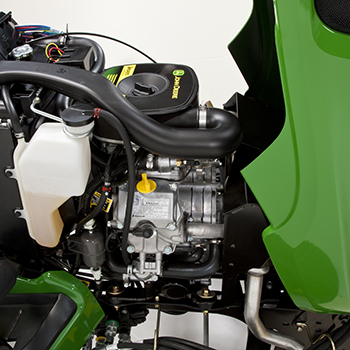 Hood opened to show engine
Hood opened to show engine
The 25.5-hp (19-kW) liquid-cooled V-twin engine has a large 45.5-cu in. (745-cc) displacement to provide plenty of power and torque for excellent performance in any operating condition. The one-piece hood is hinged to open for convenient engine service.
Key engine features include:
- Liquid cooling
- Longer engine life
- Quieter operation
- Improved fuel economy
- V-twin cylinder design
- Smoother running
- Easier starting
- Overhead valve (OHV) design to provide more efficient airflow for improved combustion
- More horsepower and torque per cubic inch of displacement
- Better cooling for longer engine life
- Reduced oil consumption
- Improved fuel economy
- Full-pressure lubrication with replaceable oil filter that provides plenty of clean oil for long engine life
- Horizontal crankshaft with a drive shaft connection to the transmission for positive power transfer
- Aluminum block and cast-iron cylinder liners
- Efficient heat dissipation
- Strength and durability with less weight
- Low exhaust emissions to meet U.S. Environmental Protection Agency (EPA) clean air standards
- Liquid cooling for consistent operating temperatures
- OHV for efficient lean burn combustion
- Precise air-to-fuel ratio control with electronic fuel injection
- Closed crankcase ventilation re-circulates and burns crankcase hydrocarbons
- Oil drain valve with hose and oil filter drip tray for easy, no-mess maintenance
- Electronic ignition for quick, sure starts
- Rubber engine mounts
- Vibration-free operation
- Lower noise
- Electric fuel pump ensures positive fuel delivery for fast starts and smooth running
- Solenoid-shift starter ensures that starter stays engaged until key switch is released for fast cold-weather starts
Air intake system
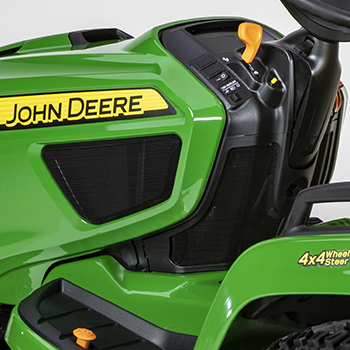 Air intake screens on hood and pedestal
Air intake screens on hood and pedestal
 Radiator screen pulled out for cleaning
Radiator screen pulled out for cleaning
Engine intake air is drawn in through screened panels at the base of the pedestal and on the right and left sides of the tractor hood:
- Cleanest and coolest area of the tractor
- Pre-cleans the air to keep large chaff and debris from entering the radiator or air cleaner
- Easy to clean and service so engine operates at optimum temperature
An inertia-discharge canister with dry-type paper element surrounded by a foam precleaner cleans intake air for long engine life:
- Ejects large dirt particles before they make contact with the filter
- Provides dual protection against dirt entering the engine
- Easily removed for cleaning or replacement
- Recommend the air filter be replaced and the precleaner cleaned annually or every 200 hours, whichever comes first
Electronic fuel injection
Electronic fuel injection (EFI) offers many important performance advantages:
- Immediate starting in hot or cold ambient temperatures or after long periods of seasonal storage
- No choke linkage for the user to operate
- No engine warmup required, so the implement can be engaged immediately after the engine starts
- Greater horsepower and torque responsiveness
- Higher reliability with the elimination of vapor locking, misfiring, run-on, and after-bang
- Automatic altitude compensation
- Delivers fuel precisely
- Reduces the potential for plug fouling
Fuel tank has a large 5.2-U.S. gal. (19.7-L) capacity
 Fuel cap and tank (shown on X758 Diesel Tractor)
Fuel cap and tank (shown on X758 Diesel Tractor)
A large, 5.2-U.S. gal. (19.7-L) capacity fuel tank holds enough fuel for extended operation between refills:
- Fuel-fill location is on the left fender for easy access, increased safety, fewer spills, and convenience during filling.
- In-tank electric fuel pump supplies ample fuel flow to eliminate vapor lock and ensure quick engine starts, even after months of storage.
Battery and alternator are large capacity
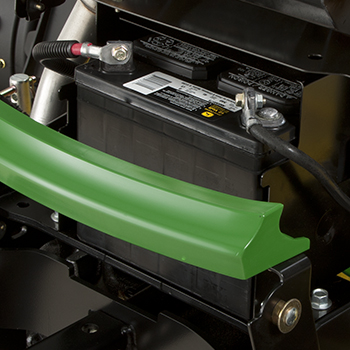 Battery located at front of tractor frame
Battery located at front of tractor frame
A high-capacity regulated alternator charging system provides plenty of power to quickly recharge the battery and run electrical equipment, such as lights or a sprayer:
- 20-amp alternator is provided as standard equipment on gasoline engines.
- An optional 20-amp auxiliary alternator kit operates in parallel with the standard 20-amp engine-equipped alternator to bring the total of 12-V electric power to 40 amps.
A large-capacity, 300 cold-cranking amp battery provides plenty of cranking power for quick, sure starts in cold weather:
- Mounted at the front of the tractor frame for easy accessibility
54-in. (137-cm) and 60-in. (152-cm) Edge™ High-Capacity (HC) Mower Decks are heavy duty
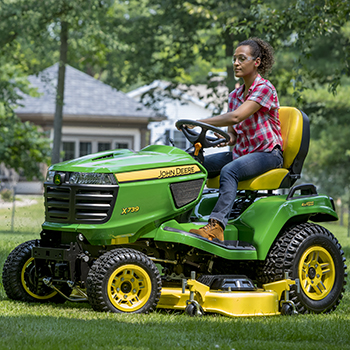 X739 Tractor mowing with 54-in. (137-cm) HC Mower Deck
X739 Tractor mowing with 54-in. (137-cm) HC Mower Deck
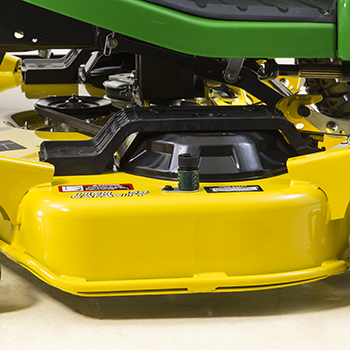 Side view of mower deck
Side view of mower deck
A deep-deck design of 5.5 in. (14 cm) delivers excellent airflow so material can be processed quickly and efficiently. The deck is stamped from 9-gauge, 0.15-in. (3.8-mm) steel and has welded-on reinforcement at the bottom edge for extra strength and durability.
 60-in. (152-cm) HC Mower Deck top view
60-in. (152-cm) HC Mower Deck top view
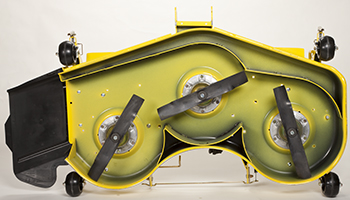 54-in. (137-cm) HC Mower Deck bottom view
54-in. (137-cm) HC Mower Deck bottom view
High-capacity mower decks are formed in a hydraulic press to minimize the number of welds and provide a smooth underside for reduced material buildup:
- Wider and higher discharge opening provides an even clipping dispersal for an excellent finished appearance in all conditions.
- Durable plastic deflector spreads grass clippings evenly across the lawn, is hinged, and can be raised to minimize the storage space required.
- 1-in. (2.5-cm) cold-forged spindles are heat-treated for strength and supported by ball bearings.
- Front edge is raised above the blade plane to allow even cutting of tall grass.
- Blade overlap is greater than many conventional decks for a clean cut.
- Mower can side-discharge, mulch (optional), or use a Power Flow™ collection system (optional).
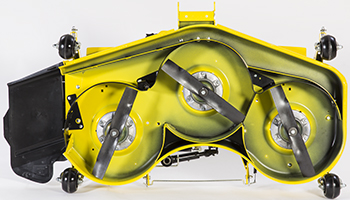 MulchControl with baffle closed
MulchControl with baffle closed
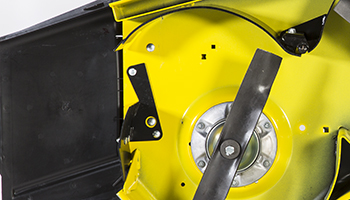 MulchControl with baffle open
MulchControl with baffle open
The MulchControl attachment makes mulching more practical for many mowing situations because it not only does an excellent job of mulching but it also allows the mower to be easily converted for times when it is more desirable to side discharge or collect the lawn material. Advantages of mulching grass clippings include:
- A beautiful looking lawn
- Grass clippings not blown onto the operator, driveways, or flower beds
- Less fertilizer use
- Elimination of the effort needed to dispose of clippings
MulchControl is an innovative, simple design that is easy to use and maintain:
- The MulchControl attachment includes baffles to control the flow of material under the deck.
- The left mower blade area is completely enclosed and optimized for mulching, thus will mulch even when the mower is in the side-discharge mode.
- Baffles around the center and right blades are optimized for mulching when the discharge baffle is closed.
MulchControl operation
 MulchControl handle (standard with MulchControl)
MulchControl handle (standard with MulchControl)
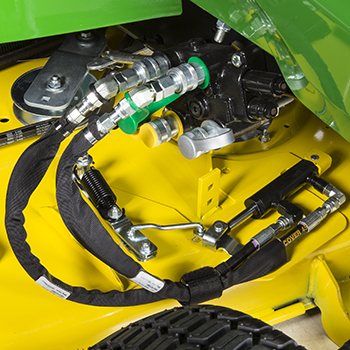 Hydraulic MulchControl actuator option
Hydraulic MulchControl actuator option
The optional MulchControl attachment comes with a handle on top of the mower deck that is used to open and close the discharge baffle:
- The operator is required to get off of the machine in order to engage or disengage mulch mode.
An optional hydraulic MulchControl actuator attachment is available to replace the standard control lever and allow the operator to control MulchControl from the seat using the tractor’s hydraulic control lever.
NOTE: To have hydraulic control of the MulchControl baffle, both MulchControl and hydraulic MulchControl actuator attachments must be ordered. The hydraulic MulchControl actuator is an extra-cost option for the MulchControl attachment.
Changing from mulching to side discharge or vice versa with the hand lever or hydraulic MulchControl actuator option takes only a few seconds.
MulchControl is well-suited to the following mowing situations:
- Usually mulch, but side discharge when grass gets too long
- Usually side discharge, but would like to be able to close the chute to control clippings
- Always mulch a main lawn, but often side discharge secondary lawns
- Bag clippings, but want to go farther before emptying bags
MulchControl puts the operator in control of the clippings. Now the operator can have all the benefits of mulching with the ability to easily change to side-discharge or bagging when needed.
MulchControl limitations
While in the side-discharge mode, MulchControl will still mulch about one-third of the material. Therefore, the side-discharge mode is essentially a partial-mulch mode. This can be an advantage when side discharging or bagging, as it helps to reduce the amount of material being discharged. Other times this could work as a disadvantage:
- When cutting strong southern grasses, such as Zoysia and Bermuda
- When cutting in wet, high-growth conditions, such as those found in the Pacific Northwest United States
- When optimum bagging and lawn clean-up is desired
MulchControl compatibility
MulchControl is a field-installed attachment. Mulching blades are included:
- MulchControl is for 2015 and newer X700 Signature Series Tractor and:
- 9074M 54-in. (137-cm) HC Mower Deck (serial number 030,001-070,000)
- 9078M 54-in. (137-cm) HC Mower Deck (serial number 070,001-)
- 9075M 60-in. (152-cm) HC Mower Deck (serial number 030,001-070,000)
- 9079M 60-in. (152-cm) HC Mower Deck (serial number 070,001-)
- Optional hydraulic MulchControl actuator (BUC10536) is available for model year 2019 and newer mower decks (9078M and 9079M) only. In addition, mower must be equipped with the basic MulchControl attachment.
NOTE: The hydraulic MulchControl actuator is not available for the 48-in. (122-cm) Accel Deep™ Mower Deck.
Order:
BM26300 MulchControl attachment (54 HC)
BM25258 MulchControl attachment (60 HC)
BUC10536 Hydraulic MulchControl actuator
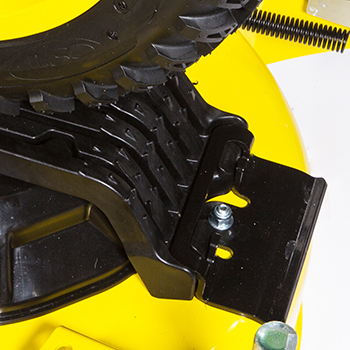 Tire-grab feature and shark tooth shaped grips
Tire-grab feature and shark tooth shaped grips
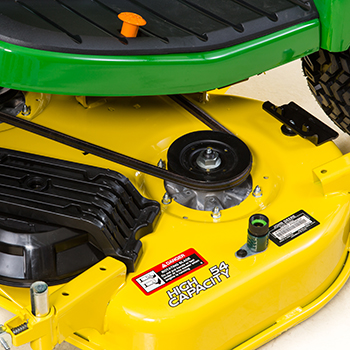 Drive-over ramp removed for spindle access
Drive-over ramp removed for spindle access
Ramps are provided to permit driving over the mower deck for installing and removing it from the tractor:
- Constructed of 30 percent glass-filled polypropylene for strength to carry the weight of the tractor
- Polypropylene material will not rust or corrode for lasting good appearance
- Shark tooth shaped grips designed into the ramp inclines for added wheel traction when driving onto the mower deck
- Tire grab at the rear of the ramp gives extra wheel traction
- Ramps removed and replaced without tools to permit convenient servicing of the mower spindles
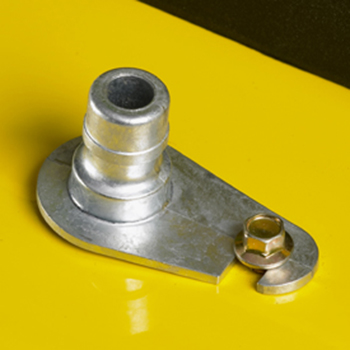 Mower wash port
Mower wash port
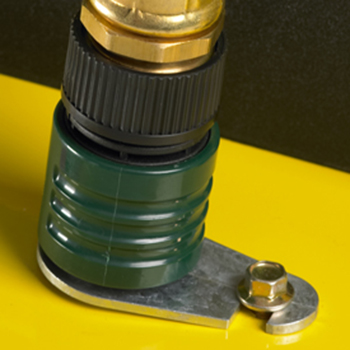 Mower wash port with hose connector
Mower wash port with hose connector
A wash port is provided to make cleaning the underside of the mower deck easy:
- Hose connector is included with the mower deck.
Optional high-performance mulching attachment
 Mulching attachment components (48 HC shown)
Mulching attachment components (48 HC shown)
The high-performance mulching attachment provides excellent mulching performance:
- This is a high-performance mulching attachment that includes formed steel baffles to control the material and special mulching blades for superior performance.
- The special mulching blades that are included can also be used for side discharging and collecting, though overall performance may be slightly less than with the standard blades.
- Order: BM23977, 54 HC mulching attachment or BM23978 60 HC mulching attachment
Optional MulchControl™ attachment
Mower deck attachability
 X758 Tractor driving onto high-capacity mower deck
X758 Tractor driving onto high-capacity mower deck
High-capacity mower decks have ramps positioned on top of the deck for easy installation:
- On a four-wheel drive (4WD) tractor, the operator can simply drive onto and over the deck.
- On a two-wheel drive (2WD) tractor, the operator must back onto and over the deck.
To remove the mower deck:
- Disconnect the drive shaft.
- Unlock the draft arm locks.
- Back or drive the tractor onto and off the mower deck.
- On a 4WD tractor, the operator can simply back onto and off the deck.
- On a 2WD tractor, the operator can simply drive forward onto and off the deck.
Optional AutoConnect™ drive (BM25677)
 X758 Tractor driving onto high-capacity mower deck
X758 Tractor driving onto high-capacity mower deck
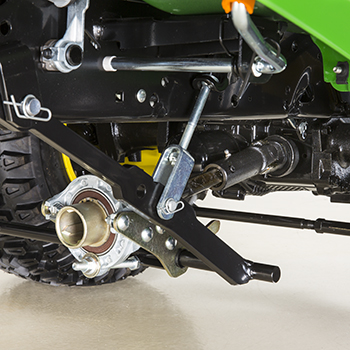 AutoConnect option installed on X758 Tractor
AutoConnect option installed on X758 Tractor
The AutoConnect driveshaft is an optional kit that will automatically connect or remove the drive from the mower deck to the tractor's mid power take-off (PTO) shaft.
The AutoConnect drive does not need to be removed from the tractor when using front-powered equipment.
Drive-over mower quick reference (major steps)
John Deere has designed a system that makes it easy to remove and reinstall the mower deck. A few steps need to be followed carefully to ensure success.
The list below includes the major steps. Refer to the operator’s manual for a more detailed procedure. The tractor most likely has the mower already installed, so these steps begin with the removal procedure.
DRIVEJD - Always Dependable Product
Mower removal steps
Drive tractor to level area.
Ready mower deck.
- Adjust wheels and lower mower deck
- Draft arms removed (front) and released (rear)
- Power take-off (PTO): disconnect if manual PTO-connect system, then back up to clear rear draft arms (If equipped with AutoConnect™, backing up also disconnects the PTO)
- Raise rear draft arms
Increase engine speed, engage traction assist, and drive over.
Mower installation steps
Verify tractor and mower are ready.
- Alignment of tractor and mower deck
- Draft arms up
- PTO in correct position (If manual PTO connect, place shaft in mower hanger)
Engage traction assist, increase engine speed, and drive or back over.
Join mower to tractor.
- Alignment and attachment verified and PTO connected
- Draft arms hookup, front
- Position mower wheels
Done! Set mower deck height and mow.
Four-year or 700-hour bumper-to-bumper warranty is standard
An exclusive 4-year or 700-hour (whichever comes first), single-source, bumper-to-bumper warranty* is standard for all John Deere X700 Series Tractors.
- The warranty is hassle free, with one company handling all of the paperwork.
- Premium features of X700 Series Tractors allow for this longer warranty period, with more coverage than comparable tractors.
*Term limited to years or hours used, whichever comes first, and varies by model. See the LIMITED WARRANTY FOR NEW JOHN DEERE TURF AND UTILITY EQUIPMENT at JohnDeere.com or JohnDeere.ca/TUWarranty for details.
Four-wheel power steering for superior maneuverability and trimming
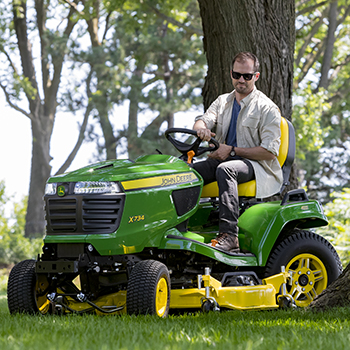 X734 Tractor trimming around tree
X734 Tractor trimming around tree
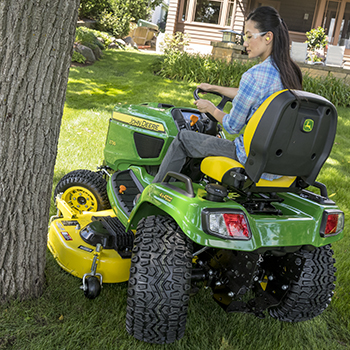 X739 Tractor trimming around a tree
X739 Tractor trimming around a tree
Power steering is standard equipment on all X700 Series Tractors. It provides effortless, automotive-like control:
- Reduced operator fatigue
- Better maneuverability
- Increased productivity
Four-wheel power steering on the X734, X739, and X754 Tractors provides very significant maneuverability and trimming advantages over two-wheel-steering equipped tractors:
1. The uncut circle diameter is greatly reduced, eliminating or greatly reducing the need to back up when trimming around trees, shrubs, etc.
- Cutting inside turns created by landscaping, flower beds, etc. can also be done much more efficiently with a four-wheel-steer equipped tractor.
2. Interference from the mower and tractor wheels is eliminated because they are several inches away from the object being trimmed around.
- When cutting rectangle-shaped areas, square corners can be cut more effectively and efficiently.
3. The outside turning circle is reduced, decreasing the time spent turning and increasing mowing efficiency.
The X739 Tractor has both full-time four-wheel drive (4WD) and four-wheel steering, which gives it the optimum in both traction and maneuverability.
|
Two-wheel steer (X730, X750) |
Four-wheel steer (X734, X754) |
Full-time 4WD (X738, X758) |
Full-time 4WD with four-wheel steer (X739) |
Turning radius |
25 in. (63.5 cm) |
21 in. (53.3 cm) |
25 in. (63.5 cm) |
21 in. (53.3 cm) |
Uncut circle radius (60- in. (152-cm) mower deck) |
28 in. (71.1 cm) |
6 in. (15.2 cm) |
28 in. (71.1 cm) |
6 in. (15.2 cm) |
Turns lock-to-lock left |
2.4 |
2.5 |
2.3 |
2.2 |
Turns lock-to-lock right |
2.4 |
2.5 |
3.1 |
2.8 |
Hydrostatic four-wheel drive (4WD) with Twin Touch™ control gives superior traction and easy operation
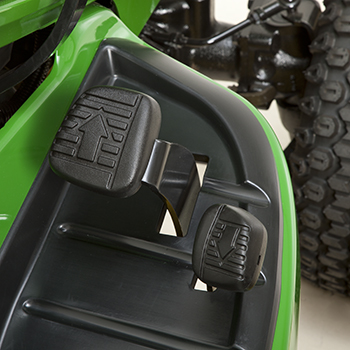 Twin Touch foot control
Twin Touch foot control
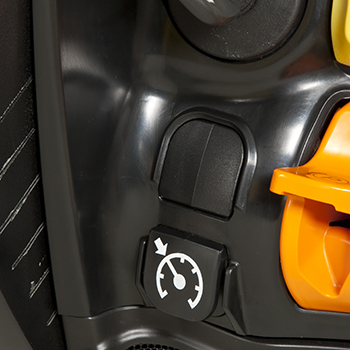 Cruise control
Cruise control
Twin Touch foot pedals control the speed and direction of travel:
- Automotive-type accelerator control for easy operation
- Twin Touch design that allows operator to change direction without lifting foot off platform
- Large pedal surface for increased operator comfort
When the master brake pedal is depressed, the power take-off (PTO) and cruise control disengage.
Cruise control is standard equipment:
- To engage, push in on the cruise lever and hold until the foot is removed from the forward pedal.
- For emergency stop, the cruise control can be released by pushing on the master brake pedal or pushing down on the forward pedal.
Heavy-duty two-wheel steer or four-wheel steer transaxle
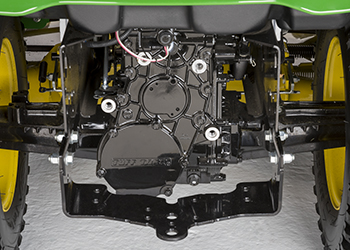 X758 two-wheel steer transaxle shown
X758 two-wheel steer transaxle shown
A rugged, heavy-duty commercial hydrostatic transaxle handles a wide variety of ground-engaging applications and commercial mowing usage. A hitch for tow-behind equipment is included. The tractor frame extends behind the transaxle to provide mounting points for the category 1 3-point hitch and Click-N-Go™ mounting brackets.
Many quality features are provided:
- Universal joint splined drive shaft between the engine and transmission is durable and gives efficient power transfer (no belts, no slippage, no power loss).
- Shaft drive output through continuous live transmission PTO has no belts to slip or wear out.
- Internal hydraulic PTO with multi-disk clutch pack:
- Soft, smooth clutch engagement
- Long disk life with continuous oil bath
- No service required, as disks are self-adjusting
- Internal, wet-disk brakes:
- Isolated from dirt, rust, ice, or other contaminants for effective brake operation
- Constantly cooled by transmission fluid to minimize wear and eliminate loss of brakes from overheating
- Quiet design virtually eliminates hydrostatic whine.
- Large, efficient 8-cc charge pump produces excellent flow and pressure to allow operating a variety of hydraulic powered equipment.
- Externally mounted, oil-filled shock absorber in the transmission control system ensures smooth starts and stops.
- Exceptional strength and durability:
- Automotive-type forged flanged axles
- Cast-iron axle housings
- Uses an axial piston-type hydrostatic pump and motor versus less-efficient ball-type rotating groups
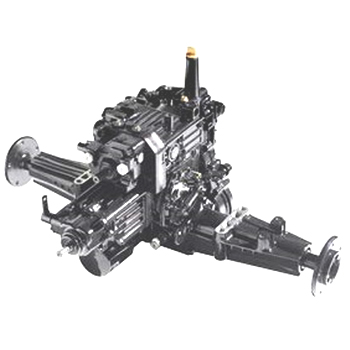 Two-wheel steer hydrostatic transaxle
Two-wheel steer hydrostatic transaxle
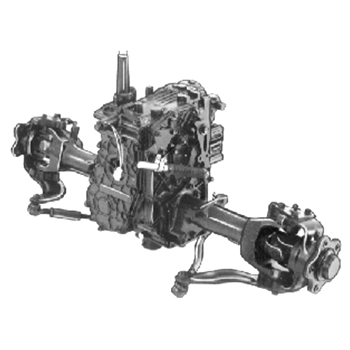 Four-wheel steer hydrostatic transaxle
Four-wheel steer hydrostatic transaxle
Two-wheel drive (2WD) and 4WD tractors use similar transaxles, however, four-wheel steer tractors have additional features that allow the rear wheels to turn.
 Differential lock control
Differential lock control
Infinite control of ground speed and smooth change of direction provide efficiency and operator convenience. The differential lock provides positive power to both drive wheels for increased traction. It can be engaged by the operator as needed.
| Forward | 0 to 8.5 mph (0 to 13.7 km/h) |
| Reverse | 0 to 6 mph (0 to 9.7 km/h) |
Transmission oil cooler
The transmission oil cooler is standard equipment:
- Helps keep oil temperatures cooler during high draft load operations
- Separate automotive-style cooler that provides increased capacity for the oil cooler as well as the radiator, when compared to an oil cooler internal to the radiator
Full-time 4WD for superior traction
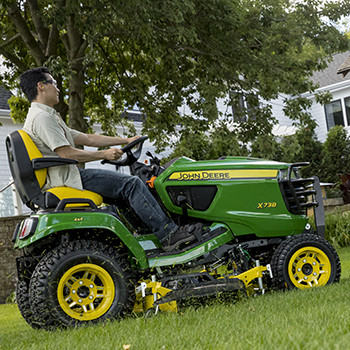 X738 Tractor mowing
X738 Tractor mowing
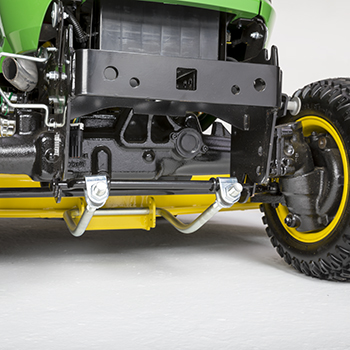 Full-time 4WD front axle
Full-time 4WD front axle
The full-time 4WD front axle provides a superior combination of traction and maneuverability. When the tractor is in a turn, the front wheels need to rotate faster because of the larger arc, compared to the rear wheels, they are traveling in. The hydrostatic front-wheel motors automatically increase the average travel speed of the front wheels when the tractor is in a turn.
The full-time 4WD system optimizes steering performance to provide maneuverability and trimming ability comparable to that of 2WD models, turning radius of 25 in. (63.5 cm) for two-wheel steer models and 21 in. (53.3 cm) for four- wheel steer models, with the added benefit of four-wheel traction.
Full-time 4WD front-wheel motors are powered by the same pressurized hydraulic fluid that powers the rear transaxle drive motor:
- Hydraulic lines move the pressurized fluid from the rear axle to the front-wheel drive motors, located near the center of the front axle, after the oil has passed through the rear transaxle drive motor.
- The two front wheel motors receive fluid in parallel so each gets the amount of fluid needed to enable different speeds during turns, similar to a differential assembly, and allow smooth turns.
- Turning radius of tractors with full-time 4WD is the same as for 2WD models, and considerably less than the turning radius for tractors with mechanical 4WD.
- Full-time 4WD functions in forward and reverse.
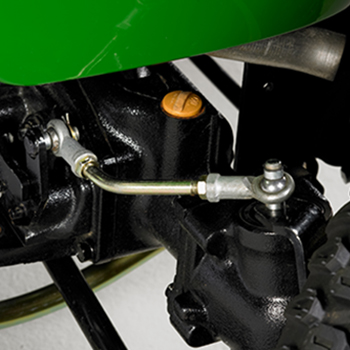 Control arm increases front-wheel speed in turns
Control arm increases front-wheel speed in turns
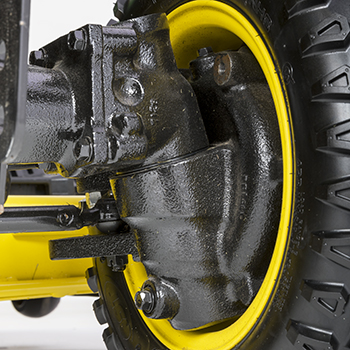 Front-wheel drop-axle
Front-wheel drop-axle
- A control rod (looks similar to a steering drag link) adjusts the swash plate of the variable-speed wheel motors, so each wheel motor is operated at the optimum speed during turns to minimize tire scuffing and assist in making tight turns.
- Front-wheel drop-axles provide extra-tight steering capability, improved ground clearance, and include speed-reduction gearing.
Operator station is comfortable and convenient
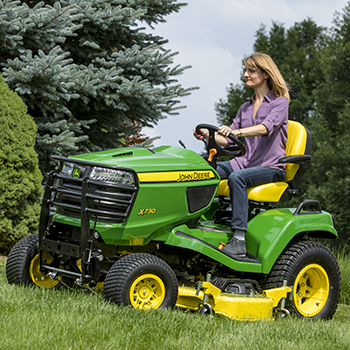 X730 Tractor mowing
X730 Tractor mowing
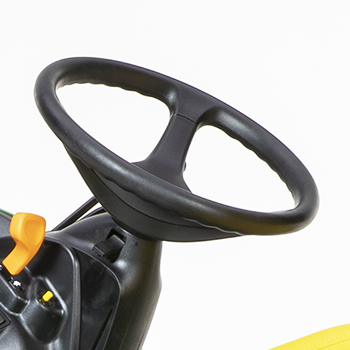 Tilt steering wheel
Tilt steering wheel
The tilt steering wheel can be adjusted for optimum operator comfort:
- Six positions can be selected with the push of a lever for the most comfortable setting.
- The full-up position makes getting on and off the tractor easy.
- The steering wheel is designed for comfortable, no-slip operation.
Two-piece tilt-back seat
 Seat has convenient tilt-back feature
Seat has convenient tilt-back feature
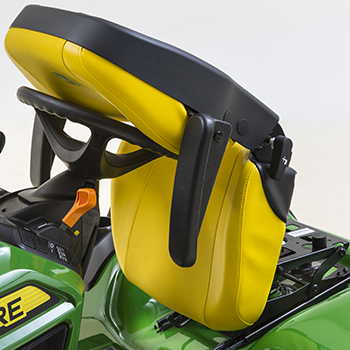 Seat tilted forward
Seat tilted forward
Two-piece, 21-in. (53-cm) high-back seat, with John Deere branded embroidery, has a thick seat cushion for lasting comfort, even after a full day of use. The back can be angled to maximize operator comfort by using a convenient lever on the side of the seat.
A four-bar adjustable seat suspension and 7-in. (18-cm) slide-rail fore-aft adjustment are provided to optimize operator comfort.
Optional armrest kit
 Adjustable armrest option
Adjustable armrest option
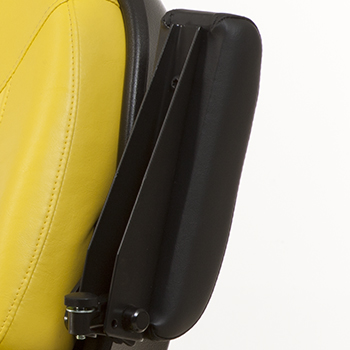 Left armrest in raised position
Left armrest in raised position
Optional armrests increase operator support and comfort, thus reducing fatigue and improving productivity, especially when mowing for extended periods of time. Armrests are adjustable to suit the operator. The embroidered logo on the seat back makes this upscale seat look as good as it feels.
Optional air-ride suspension seat
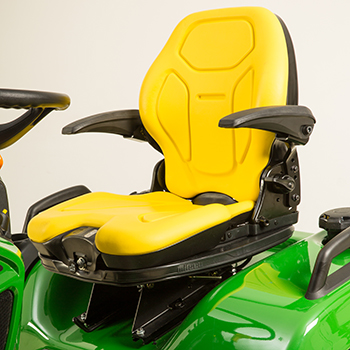 Optional air-ride suspension seat
Optional air-ride suspension seat
 Seat pressure switch and fore-aft adjustment lever
Seat pressure switch and fore-aft adjustment lever
The optional air-ride seat minimizes vibration the operator feels while using the tractor and provides a very smooth ride. This seat has a full pneumatic suspension that is easy for operators to adjust to suit their individual needs. Wide, shaped ergonomic cushions are comfortable and reduce back strain.
Features include:
- Simple switch on the front of the seat makes adjustment easy
- Back-angle adjustment
- Three-position lumbar adjustment
- Armrest height adjustment
- 7-in. (18-cm) fore-aft adjustment
Key benefits of the seat:
- Provides maximum ride comfort and quality, thus minimizing operator fatigue
- Dampens lower frequency vibration better than mechanical suspensions
NOTE: The air-ride seat is compatible with all X700 Signature Series Tractors, model year 2013 and later (serial number 010,001-). Plug and play wiring harness for use with the air-ride suspension seat has been added to model year 2019 tractors (serial number 70,001-) to reduce seat-installation time. Model year 2013-2018 (serial number 010,001-070,000) requires AM146765 wiring harness. See CCMS solution 115258 for more information.
Foot pads
 Foot pads
Foot pads
Foot pads help isolate the operator's feet from vibration:
- Provide a non-slip surface for safer mounting or dismounting the tractor
- Attractive styling
Handgrips, toolbox, cup holder, and 12-V outlet
 Toolbox and handgrip
Toolbox and handgrip
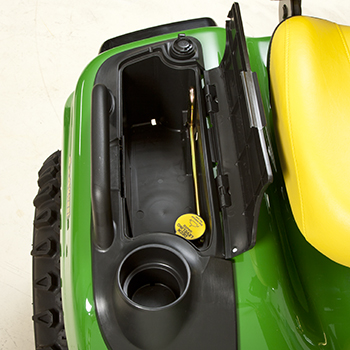 Toolbox with cover open and cup holder
Toolbox with cover open and cup holder
The fender handles provide a convenient handhold to use when getting on and off the tractor and when operating on slopes:
- Plastic material is durable and will not rust.
- The cup holder is designed to hold a variety of drink container sizes.
- Toolbox provides a safe and convenient location to store tools and supplies.
- Exact Adjust mower leveling tool and gauge storage features are provided in the tool box.
12-V outlet
 12-V outlet
12-V outlet
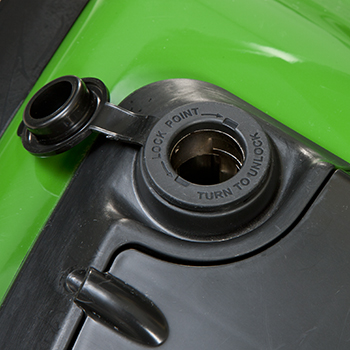 12-V outlet with cover open
12-V outlet with cover open
12-V outlet located for the convenience of connecting a variety of electrical and electronic equipment:
- Outlet switch is located on the dash for starting and stopping an electric spreader or sprayer.
Headlights and taillights provide good visibility
 Two high-quality headlights
Two high-quality headlights
Large, automotive-type headlights and taillights provide unsurpassed nighttime illumination:
- Standard 37-W halogen headlights provide excellent nighttime visibility.
- Large automotive-type taillights enhance the tractor's appearance and safety.
- Headlights, taillights, and rear work lights are easily operated with a single dash-mounted switch.
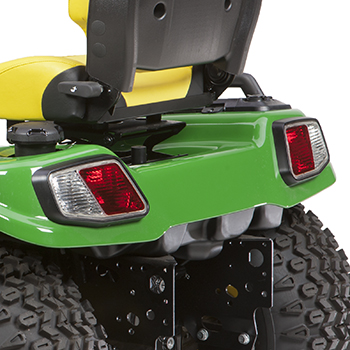 Taillights, work lights, and backup lights
Taillights, work lights, and backup lights
Rear lights provide visibility for the tractor operator and others:
- Standard backup lights can be turned on full time to double as rear work lights.
- Backup lights come on automatically when the operator depresses the reverse pedal.
Snow removal and yard care equipment
An advantage of X700 Series Garden Tractors is their ability to use attachments for snow removal and a variety of other yard-care tasks.
The front quick-hitch mounting system allows for a tool-free change between the front blade, rotary broom, and snow blower. Additional attachments available for use with the equipment listed below include:
- Quik-Tatch tractor frame weights to add ballast for traction and stability
NOTE: Ballast is required for some applications. - Tire chains or TerraGrip traction belts for extra traction when using snow-removal equipment
- Weather protection (shown below) for operator protection and comfort
47-in. (119-cm) and 54-in. (137-cm) Quick-Hitch Snow Blowers
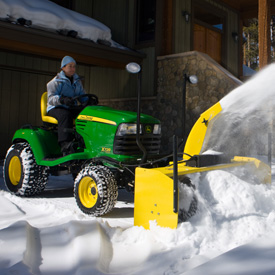 47-in. (119-cm) Snow Blower, optional front light kit shown
47-in. (119-cm) Snow Blower, optional front light kit shown
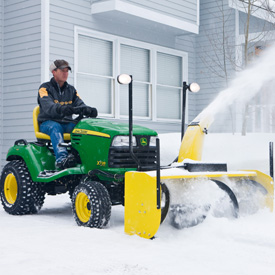 54-in. (137-cm) Snow Blower, optional front light kit shown
54-in. (137-cm) Snow Blower, optional front light kit shown
NOTE: One drift knife is standard equipment; the second (shown in images above) is optional.
The 47-in. (119-cm) and 54-in. (137-cm) Snow Blowers have the capacity to handle big snow-removal jobs.
The front quick-hitch mounting system allows for a tool-free change between the front blade, rotary broom, and snow blower.
42-in. (107-cm) and 47-in. (122-cm) Rotary Tillers
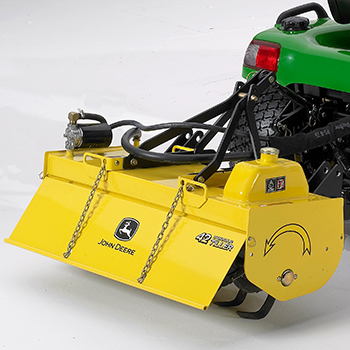 42-in. (107-cm) Hydraulic Rotary Tiller
42-in. (107-cm) Hydraulic Rotary Tiller
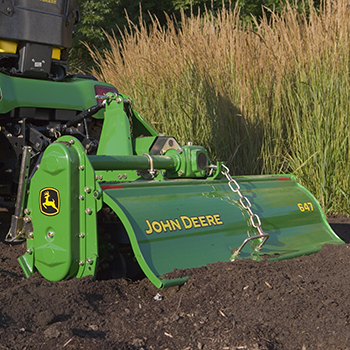 647 Rotary Tiller
647 Rotary Tiller
The 42-in. (107-cm) Hydraulic Tiller is a real time-saver in preparing seedbeds, controlling weeds, and other tillage jobs. Potential customers include homeowners, hospitals, schools, nurseries, estates, lawn and garden centers, etc. The hydraulic tiller is quieter, more powerful, and tills up to 6 in. (15 cm) of depth. This provides flexibility for jobs like sod breaking to conventional garden tilling.
A unique feature of the 42-in. (107-cm) Hydraulic Tiller is its ability to operate with either forward or reverse tine rotation. This provides flexibility for jobs from sod breaking to conventional garden tilling.
- In forward tine rotation, the hydraulic motor is on the right side and the tines turn in the same direction as the tractor tires when the tractor travels forward for tilling most soil conditions, including soil already tilled and soft soil.
- In reverse tine rotation, the hydraulic motor is on the left side and the tines turn in the opposite direction as the tractor tires when the tractor travels forward for tilling hard soils or sod.
The 647 Rotary Tiller is 47-in. (122-cm) wide and ideal for preparing seedbeds, controlling weeds, and other tillage jobs for homeowners, golf courses, hospitals, schools, and estates. It requires a tractor equipped with a Category 1, 3-point hitch and 540-rpm rear power take-off (PTO).
52-in. (132-cm) and 60-in. (152-cm) Rotary Brooms
 52-in. (132-cm) Rotary Broom (shown with optional front light kit)
52-in. (132-cm) Rotary Broom (shown with optional front light kit)
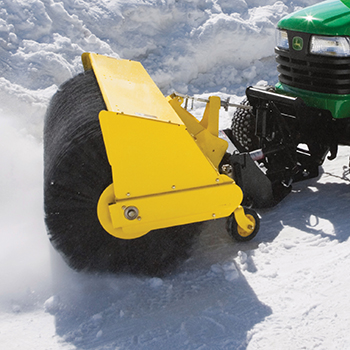 60-in. (152-cm) Heavy-Duty Rotary Broom
60-in. (152-cm) Heavy-Duty Rotary Broom
The 52-in. (132-cm) and 60-in. (152-cm) Rotary Brooms increase tractor versatility by allowing use for a variety of sweeping jobs. The broom effectively meets the needs of commercial, farm, home, and estate operators with four-season versatility:
Spring
Rotary brooms can be used to dethatch lawns and clean off tennis courts and other areas quickly and effectively.
Summer
Rotary brooms effectively perform a wide variety of sweeping jobs, including cleaning sidewalks, parking lots, driveways, construction job sites, and barns. They can also be used for backfilling trenches.
Fall
Rotary brooms can be used to sweep leaves and windrow pine needles. They sweep artificial turf and clean up spectator areas after sporting events.
Winter
Rotary brooms effectively move up to 2 in. (5 cm) of snow, which may eliminate the need for a snow thrower, depending on the geographic area.
54-in. (137-cm) and 60-in. (152-cm) Quick-Hitch Front Blades
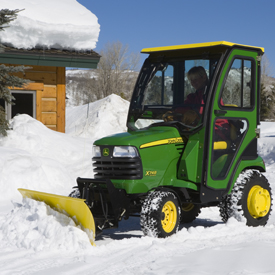 54-in. (137-cm) Quick-Hitch Front Blade
54-in. (137-cm) Quick-Hitch Front Blade
 60-in. (152-cm) Quick-Hitch Front Blade
60-in. (152-cm) Quick-Hitch Front Blade
The 54-in. (137-cm) and 60-in. (152-cm) Front Blades are excellent for moving snow, gravel, dirt, sand, or other loose material. They can be hydraulically angled up to 27 degrees right or left or used in the straight-ahead position.
Weather enclosure and hard-side cab
 Weather enclosure
Weather enclosure
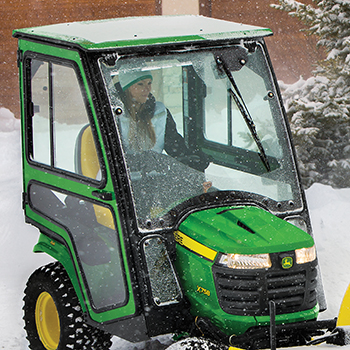 Hard-side cab
Hard-side cab
The roomy steel-frame weather enclosure shields the operator against snow, rain, sun, and wind.
This hard-side cab is rollover protection structure (ROPS) certified for extra protection:
- An electric front windshield wiper is included.
- Optional attachments for the hard-side cab include a heater, heater disconnect kit, inside and outside mirrors, rear window wiper, strobe light, work lights, switch panel fuse block kit, and optional tractor alternators to provide extra capacity to operate the cab accessories.
Instruments and controls are easy to find and use
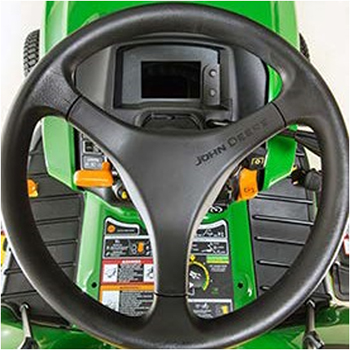 Instrumentation and controls (switch turned off)
Instrumentation and controls (switch turned off)
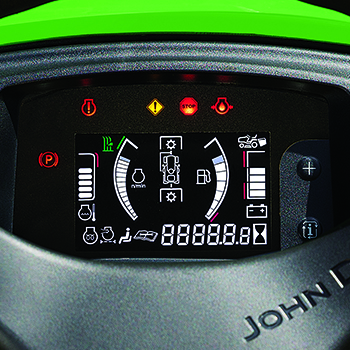 Gauges and indicator lights (switch turned on to illustrate functions)
Gauges and indicator lights (switch turned on to illustrate functions)
The contoured dash has clean, attractive styling and ergonomic controls for easy use:
- Controls are color coded for easy identification by the operator.
- Controls are logically placed and easy to reach.
- The power take-off (PTO) switch allows the operator to get fingers underneath it, like a T-handle, to pull up for easy activation.
- The reverse implement option (RIO) switch is an easy-to-see and easy-to-use yellow button.
- Cruise control activation is handled by an automotive-style button.
- Functional design of the throttle control provides good appearance and a comfortable feel.
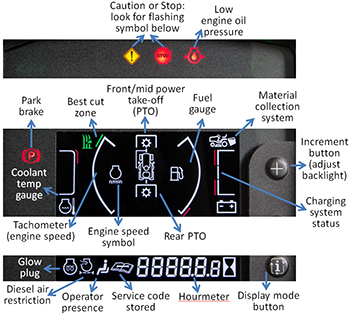 Display panel illustration with descriptions
Display panel illustration with descriptions
The instrument display has the look and feel of a modern automobile. A power-up sequence cycles lights and gauges to indicate they are working:
- Display features dark-cockpit design to minimize operator distractions.
- Display is back lit for night visibility.
- Night visibility is especially useful with snow blower use.
- Hour meter makes it easy to tell when oil changes and other maintenance should be performed.
- Electronic fuel gauge provides real-time fuel level information.
- A tachometer graphically displays engine speed.
- Target-zone graphics inform the operator of the engine speed range to use for best cut quality.
- An indicator tells the operator when the PTO is operating.
- Bright caution and stop lights capture the operator's attention when important information is on the instrument cluster.
- Damage can be prevented and repair costs reduced by addressing problems early.
- Operators are advised of what the problem is if they attempt to operate the mower with unsatisfied PTO, seat, or park brake interlocks.
- The indicators are also useful to identify the reasons the PTO or engine may have shut off when an interlock is unsatisfied.
- Operators are advised if battery voltage is low, normal, or excessive.
- The service indicator light illuminates to indicate a diagnostic error code is stored.
- On-board diagnostics provides trouble codes for use by trained technicians.
- For example, a technician will be able to test switch functionality and circuit continuity without tools.
- On-board diagnostics provides trouble codes for use by trained technicians.
Exact Adjust
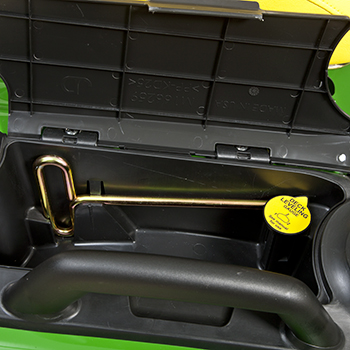 Exact Adjust tool and mower leveling gauge
Exact Adjust tool and mower leveling gauge
Exact Adjust tool and mower deck leveling gauge are stored in the toolbox to provide a convenient means of checking and adjusting the deck level:
- Used in conjunction with Exact Adjust ports for easy and accurate leveling of the mower deck for optimum mowing performance
Twin Touch™ foot control is easy to use and has cruise control
 Twin Touch foot control
Twin Touch foot control
 Cruise control
Cruise control
Twin Touch foot pedals control the speed and direction of travel:
- Automotive-type accelerator control for easy operation
- Twin Touch design that allows operator to change direction without lifting foot off platform
- Large pedal surface for increased operator comfort
When the master brake pedal is depressed, the PTO and cruise control disengage.
Cruise control is standard equipment:
- To engage, push in on the cruise lever and hold until the foot is removed from the forward pedal.
- For emergency stop, the cruise control can be released by pushing on the master brake pedal or pushing down on the forward pedal.
Differential lock
 Differential lock control
Differential lock control
A foot-operated differential lock supplies positive power to both rear drive wheels for increased traction:
- Differential lock button is conveniently located on the left footrest for easy engagement.
Parking brake control
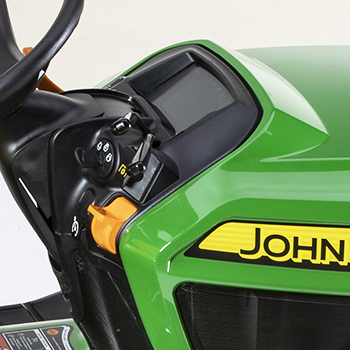 Controls shaped and located for easy use
Controls shaped and located for easy use
 Park brake control and brake pedal
Park brake control and brake pedal
The parking brake control is conveniently located below the key switch on the steering pedestal:
- Holds the brake pedal securely in the locked position
Depressing the brake pedal disengages the PTO and cruise control:
- Allows the engine to be started
- Applies wet-disk brakes (internal in transmission) for use as a parking brake
Mower deck height-of-cut control
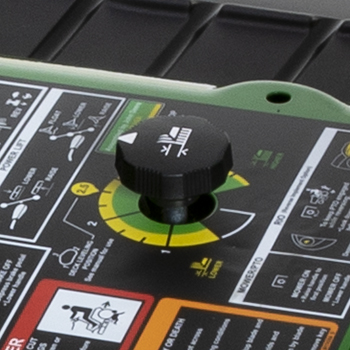 Mower deck height-of-cut control
Mower deck height-of-cut control
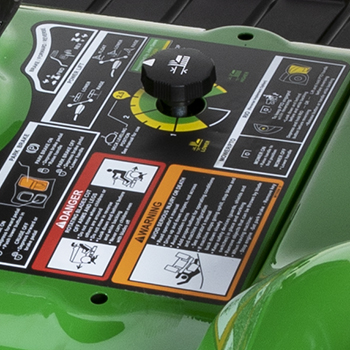 Exact Adjust ports
Exact Adjust ports
The depth stop allows setting the mower height from the operator's seat:
- Locks the mower in fully raised position so 3-point hitch equipment can be raised or lowered independently of the mower
- Returns mower deck to the same preset height each time it is lowered
- Provides a mower cut-height range from 1 in. to 5.25 in. (2.5 cm to 13.3 cm)
- Informs the operator of the approximate mower cut-height through an indicator
Exact Adjust ports on either side of the fender deck allow access to the rear mower deck height adjusting links:
- Allow mower deck to be easily leveled side-to-side
- Leveling can be done from above the fender deck by using the Exact Adjust tool
Hydraulic power steering gives effortless control
 X734 Tractor trimming around a tree
X734 Tractor trimming around a tree
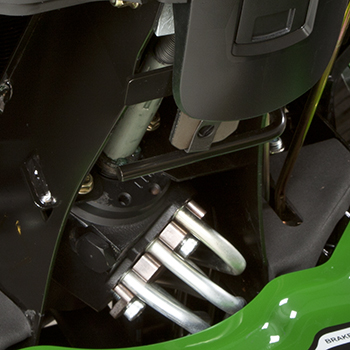 Power steering control valve
Power steering control valve
Power steering is standard equipment. It provides effortless, automotive-like control:
- Reduced operator fatigue
- Better maneuverability
- Increased productivity
|
Two-wheel steer (X730, X750) |
Four-wheel steer (X734, X754) |
Full-time four- wheel drive (X738, X758) |
Full-time four-wheel drive with four- wheel steer (X739) |
Turning radius |
25 in. (63.5 cm) |
21 in. (53.3 cm) |
25 in. (63.5 cm) |
21 in. (53.3 cm) |
Uncut circle radius (60- in. (152-cm) mower deck) |
28 in. (71.1 cm) |
6 in. (15.2 cm) |
28 in. (71.1 cm) |
6 in. (15.2 cm) |
Turns lock-to-lock left |
2.4 |
2.5 |
2.3 |
2.2 |
Turns lock-to-lock right |
2.4 |
2.5 |
3.1 |
2.8 |
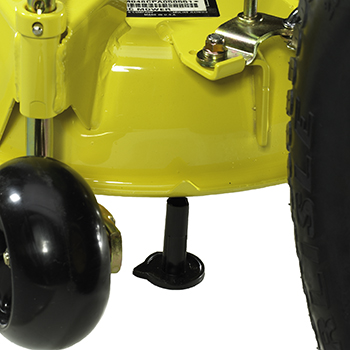 Deck-leveling gauge placed under deck
Deck-leveling gauge placed under deck
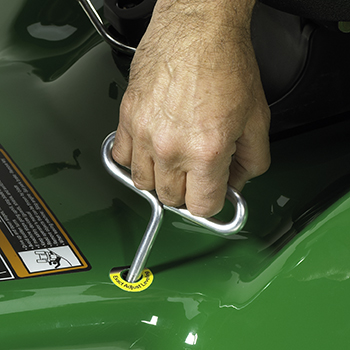 Using included ball-hex tool to level mower deck
Using included ball-hex tool to level mower deck
Consult the operator's manual for the correct adjusting procedure. Basic adjusting steps to properly level the mower deck include:
- Park the tractor on a level surface.
- Inflate tires to the correct pressure.
- Consult the label for the cutting-height knob that is located on the console of the machine. This label shows deck-leveling position and location of deck-leveling adjustment points.
- Set mower cutting-height knob to the correct deck-leveling position.
- Adjust mower wheels as necessary so they do not contact the ground surface.
- Remove the onboard deck-leveling gauge and Exact Adjust tool that are located in the tractor toolbox.
- Using the Exact Adjust ports and tool, adjust mower deck side-to-side level so the deck-leveling gauge just slips under the left and right lower deck rim. The location of adjustment points will vary slightly between decks.
- Left- and right-rear adjustment points are under the deck rim near the rear mower wheels.
- Adjust mower deck front-to-back level, if necessary.
- Loosen rear nuts equally on each side of front lift rod.
- Turn front nut equally on each side clockwise to raise front of mower or counterclockwise to lower it until gauge just slips under the front adjustment point.
- Front adjustment point varies by mower deck
- Tighten rear nuts after adjustment is complete.
- Return the gauge and tool to their storage position in the toolbox.
NOTE: The adjusting tool supplied with the tractor is an 8-mm ball-hex key. The rounded end allows for some misalignment with the bolt as the deck is adjusted.
Two-function hydraulics give effortless control of equipment
 Dual hydraulic control levers
Dual hydraulic control levers
A two-function hydraulic control system is standard equipment.
The hydraulic system allows effortless equipment control:
- Raising and lowering
- Angling and spout rotation
- Control levers
- Levers are positioned on the steering pedestal for quick, easy, and precise fingertip control of equipment.
- Lower lever has a float position, allowing front-mounted equipment such as a blade, snow blower, or rotary broom to follow the contour of the ground.
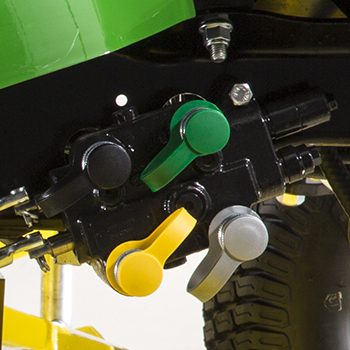 Hydraulic outlets
Hydraulic outlets
Four hydraulic couplers with color-coded covers are available for quick, easy connections.
Modern styling has a functional design
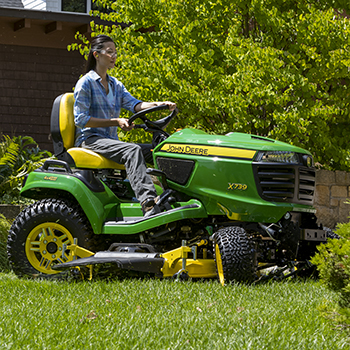 Functional and attractive design includes alloy wheels
Functional and attractive design includes alloy wheels
 Styled hood and seat
Styled hood and seat
John Deere Signature Series are the very best mowing tractors available and can also handle a wide range of other yard care chores, such as snow removal, lawn cleanup, and landscaping work. These heavy-duty tractors include models with two-wheel drive (2WD) and four-wheel drive (4WD), two- and four-wheel steering, and even a model with full-time 4WD and four-wheel steering.
Standard equipment styled alloy wheels and John Deere brand embroidery:
- Standard equipment styled alloy wheels give X700 Series Tractors a fresh, upscale appearance that goes well with their high-quality standards and superior performance.
- John Deere brand embroidery has been added to the standard equipment 21-in. (53-cm) two-piece adjustable seat to make it look as good as it feels.
The open platform is roomy and uncluttered:
- Makes getting on and off the tractor easy
- Provides ample legroom with built-in heel pockets for comfortable operation
The single-piece hood completely encloses the engine:
- Improves appearance
- Provides quieter operation
- Easy to remove for service accessibility
- Painted hood
- More scratch and scuff resistant than molded-in color
- Deep scratches repairable with paint
Important advantages for superior mowing performance and equipment versatility
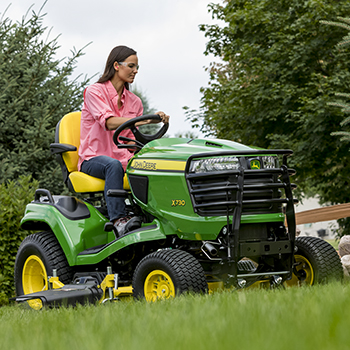 X730 Tractor mowing
X730 Tractor mowing
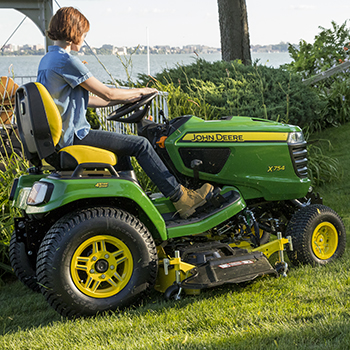 X754 Tractor mowing
X754 Tractor mowing
Available mower decks include a 48-in. (122-cm) Accel Deep™ Mower Deck or 54-in. (137-cm) or 60-in. (152-cm) Edge™ High-Capacity Mower Deck. All mowers have premium design features to give a clean, level cut and excellent performance, whether side discharging, mulching, or collecting lawn material.
X700 Signature Series Tractors offer these important performance advantages:
- Heavy-duty robotically welded frame for the strength to operate a wide variety of equipment
- Plenty of engine horsepower and torque to operate larger equipment
- Electronic fuel injection (X730, X734, X738, X739)
- Fast and sure starts
- Better fuel economy than carbureted engines
- Reduced emissions
- Diesel models (X750, X754, X758)
- Increased durability
- Improved fuel economy
- U.S. Environmental Protection Agency (EPA) Final Tier 4 compliant
- Easy-to-operate Twin Touch™ foot-controlled hydrostatic transmission
- Power steering for quick, precise control
- Four-wheel drive for optimum traction in any use and ground condition (X738 and X758)
- Four-wheel steering for unsurpassed trimming ability (X734 and X754)
- Full-time four-wheel drive and four-wheel steering for unsurpassed traction, maneuverability, and trimming ability (X739)
- Differential lock for increased traction control
- Hydraulic power take-off (PTO) clutch with soft, modulated engagement
- Shaft-driven equipment versus a belt drive
- Shaft-driven transmission versus a belt drive
- Automotive-type dash instrument cluster with gauges and indicator lights
- Two-spool hydraulic control valve with outlets
- From-the-seat adjustable mower depth stop with gauge
- Exact Adjust mower-leveling feature with onboard gauge and adjusting tool
- Automotive-type headlights and taillights
- Optional 540-rpm rear PTO
- Optional limited Category 1 3-point hitch for rear-mounted equipment
Frame is full-length welded steel for strength
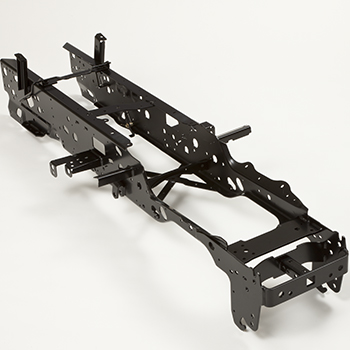 Full-length welded steel frame
Full-length welded steel frame
The full-length, welded C-channel steel frame provides plenty of strength to handle heavy equipment:
- Frame side rails are formed from 7-gauge, 0.18-in. (4.6-mm) steel for extra strength.
- The front bumper/weight bracket is formed from heavy, 0.375-in. (9.5-mm) steel.
The frame is robotically metal inert gas (MIG) welded:
- Consistent welds for maximum strength
- No bolts to come loose
A front Quik-Tatch weight bracket is designed into the frame:
- Provides a convenient way to add up to 168 lb (76 kg) of weight to the front of the tractor using four suitcase weights
- Extends ahead of the hood to act as a bumper
 Front receiver hitch
Front receiver hitch
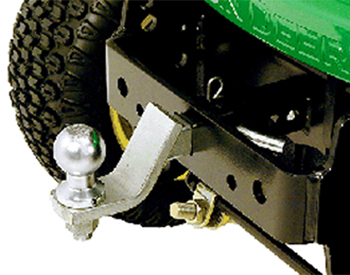 Optional drawbar/ball mount and hitch ball shown
Optional drawbar/ball mount and hitch ball shown
A front receiver hitch is designed into the frame:
- Optional drawbar/ball mount and hitch balls are available.
- Excellent for positioning trailers, boats, etc., in tight quarters.
An optional rear receiver hitch is available.
Front axle and wheel spindles are heavy duty
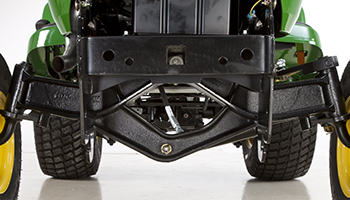 Heavy-duty cast-iron front axle (2WD shown)
Heavy-duty cast-iron front axle (2WD shown)
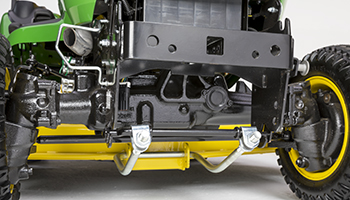 Heavy-duty cast front axle (4WD shown)
Heavy-duty cast front axle (4WD shown)
The front axles are made of strong, shock-resistant cast iron:
- Will not bend or deform, as is possible with steel-fabricated axles
- Replaceable bushings are used at the center axle pivot and spindles
- Provide excellent wear resistance
- Easy service and maintenance with grease fittings
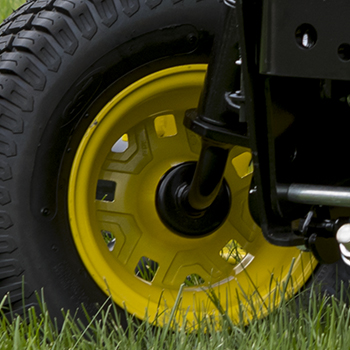 1-in. (2.5-cm) diameter front-wheel spindle (2WD)
1-in. (2.5-cm) diameter front-wheel spindle (2WD)
 Cast-iron front spindle/wheel motor (4WD)
Cast-iron front spindle/wheel motor (4WD)
The 2WD tractors use large, 1-in. (2.5-cm) diameter wheel spindles for durability:
- Have the strength to handle heavy front implements
- Provide long life at bearing surfaces
- Use sealed precision bearings in the front wheels for long life
The 4WD tractors use heavy-duty cast and machined front spindle and wheel motor assemblies for durability and long life.
Thoughtful designs promote safe operation and convenient service
Using reverse implement option (RIO)
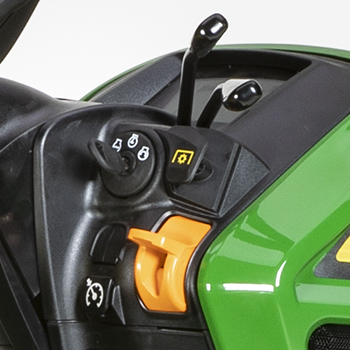 Power take-off (PTO)/RIO switch (yellow switch)
Power take-off (PTO)/RIO switch (yellow switch)
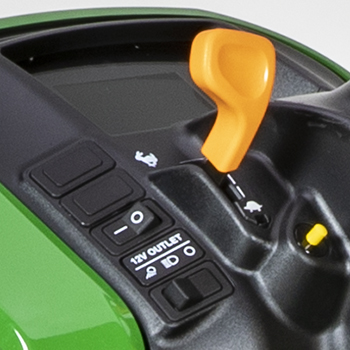 Left-hand RIO switch (yellow button)
Left-hand RIO switch (yellow button)
CAUTION: Children or bystanders may be injured by rotating blades. Before traveling forward or rearward:
- Carefully check the area around the machine.
- Disengage the mower before backing up.
NOTE: Backing up while the mower is engaged is strongly discouraged. RIO should be used only when operating another attachment or when the operator deems it necessary to reposition the machine with the mower engaged.
- Stop forward travel.
- Look behind the machine to be sure there are no bystanders.
- Push and hold in the RIO switch while depressing the reverse pedal slightly
NOTE: If the mower or other attachment stops while repositioning the machine, return the attachment engagement switch to the off position. Start the engine and engage mower or other attachment. Begin again with step 2. - Release the RIO switch and reposition the machine as the machine begins to move rearward.
- Resume forward travel. The mower or other attachment should continue operating.
- Repeat procedure to position the machine again.
NOTE: For tractors equipped with an optional front PTO kit installed, the front implements will rotate while backing up without engaging RIO.
Interlock switches
The hydrostatic transmission foot pedals must be in neutral, with brake depressed, PTO disengaged, and the ignition key used, before the tractor will start.
Once the tractor is running, the engine automatically shuts off if the operator leaves the seat with the PTO engaged, brake pedal unlocked, or hydrostatic foot controls out of the neutral position.
Serviceability is convenient with easy-open hood
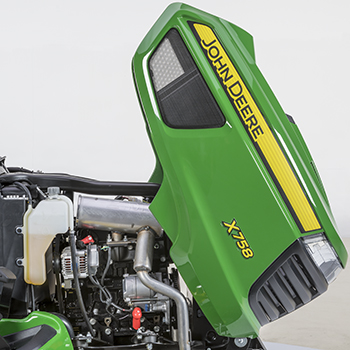 One-piece hood is easy to open and remove
One-piece hood is easy to open and remove
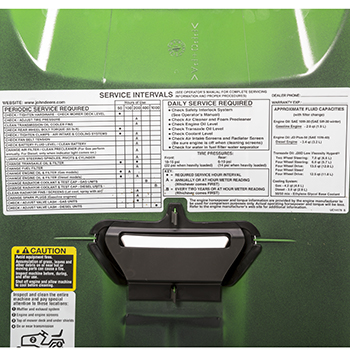 Service interval decal located under hood
Service interval decal located under hood
The one-piece hood opens easily to permit checking and servicing the engine:
- A service-interval decal is provided inside the tractor hood for convenience when servicing the tractor.
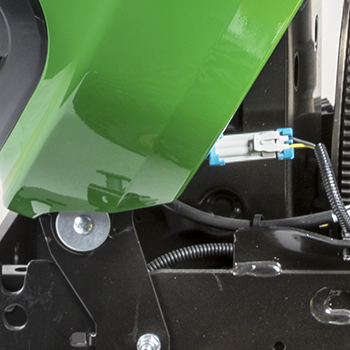 Hood pivot and wiring connector
Hood pivot and wiring connector
 Hood removed for service
Hood removed for service
If necessary to do more extensive service, the hood can easily be completely removed without tools:
- Wiring connector allows headlight wiring to be easily disconnected.
- Hood can be raised off pivots and easily removed without use of any tools.
 Radiator screen pulls out for easy cleaning
Radiator screen pulls out for easy cleaning
 Deck-leveling gauge and tool stored in tractor toolbox
Deck-leveling gauge and tool stored in tractor toolbox
A screen keeps material from building up on the radiator and can be easily removed for cleaning.
A convenient deck-leveling gauge and Exact Adjust tool are provided:
- Exact Adjust tool and mower deck leveling gauge are stored in the toolbox to provide a convenient means of checking and adjusting the deck level.
-
Used in conjunction with Exact Adjust ports for easy and accurate leveling of the mower deck for optimum mowing performance
-
MulchControl™ system options for Accel Deep™ and High-Capacity Mower Decks are convenient to use
MulchControl advantages and benefits
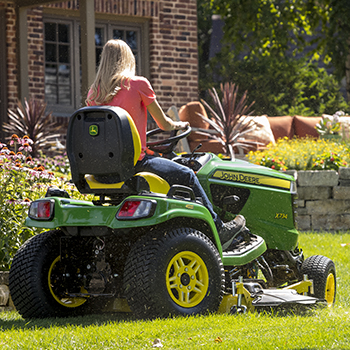 X730 Tractor mowing
X730 Tractor mowing
 X730 Tractor with 48A Mower Deck
X730 Tractor with 48A Mower Deck
The MulchControl attachment makes mulching more practical for many mowing situations because it not only does an excellent job of mulching but it also allows the mower to be easily converted for times when it is more desirable to side discharge or collect the lawn material. Advantages of mulching grass clippings include:
- A beautiful looking lawn
- Grass clippings not blown onto the operator, driveways, or flower beds
- Less fertilizer use
- Elimination of the effort needed to dispose of clippings
How MulchControl works
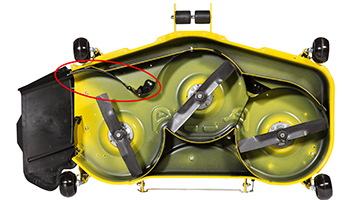 MulchControl baffle open
MulchControl baffle open
 MulchControl baffle closed
MulchControl baffle closed
MulchControl is an innovative, simple design that is easy to use and maintain:
- The MulchControl attachment includes baffles to control the flow of material under the deck.
- The left mower blade area is completely enclosed and optimized for mulching, thus will mulch even when the mower is in the side-discharge mode.
- Baffles around the center and right blades are optimized for mulching when the discharge baffle is closed.
MulchControl handle
 MulchControl baffle closed
MulchControl baffle closed
 MulchControl handle (shown on 60-in. (152-cm) Mower Deck)
MulchControl handle (shown on 60-in. (152-cm) Mower Deck)
- The MulchControl handle is located on top of the mower deck and used to open and close the discharge baffle.
- The operator is required to get off of the machine in order to engage or disengage mulch mode.
- Changing from mulching to side discharge or vice versa takes only a few seconds.
MulchControl is well-suited to the following mowing situations:
- Usually mulch, but side-discharge when grass gets too long
- Usually side discharge, but would like to be able to close the chute to control clippings
- Always mulch a main lawn, but often side discharge secondary lawns
- Bag clippings, but want to go farther before emptying bags
- The MulchControl baffle can be opened or closed with the Power Flow™ blower installed. The Power Flow blower will run without material when the baffle is closed.
MulchControl puts the operator in control of the clippings. Now the operator can have all the benefits of mulching with the ability to easily change to side-discharge or bagging when needed.
Hydraulic MulchControl actuator option (54 HC and 60 HC Mowers only)
For model year 2019 and newer 54-in. (137-cm) and 60-in. (152-cm) High Capacity (HC) Mower Decks (serial number 70,001-) used on X700 Signature Series Tractors, an optional hydraulic MulchControl actuator attachment is are available to provide hydraulic actuation of the MulchControl baffle from the tractor seat:
- The optional hydraulic MulchControl actuator is the control only and also requires a MulchControl attachment.
- It is operated with the tractor’s hydraulic control lever.
- The mower deck can be converted from wide-open side-discharge mode to fully-chambered mulch mode.
- The hydraulic MulchControl actuator attachment is field-installed and compatible with model year 2019 and newer 54 HC or 60 HC Mower Decks (serial number 70,001-) installed on an X700 Signature Series Tractor.
MulchControl limitations
While in the side-discharge mode, MulchControl will still mulch about one third of the material. Therefore, the side-discharge mode is essentially a partial-mulch mode. This can be an advantage when side discharging or bagging, as it helps to reduce the amount of material being discharged. Other times this could work as a disadvantage:
- When cutting strong southern grasses, such as Zoysia and Bermuda
- When cutting in wet, high-growth conditions, such as those found in the Pacific Northwest United States
- When optimum bagging and lawn clean-up is desired
Compatibility
MulchControl is a field-installed attachment and compatible with 2013 and newer X700 Signature Series Tractor (SN 10,001-) with one of the following mower decks:
- 9077M 48-in. (122-cm) Accel Deep Mower Deck
- 2015-2018 9074M 54-in. (137-cm) or 9075M 60-in. (152-cm) HC Mower Deck (SN 030,001-070,000)
- 2019 and newer 9078M 54-in. (137-cm) or 9079M 60-in. (152-cm) HC Mower Deck (SN 070,001-)
MulchControl is a field-installed attachment. Mulching blades are included:
- Optional hydraulic MulchControl actuator (BUC10536) is available for model year 2019 and newer 9078M 54-in. (137-cm) or 9079M 60-in. (152-cm) HC Mower Deck (SN 070,001-). In addition, mower must be equipped with a basic MulchControl attachment.
Order:
BM24993 48A MulchControl attachment
BM26300 54-in. (137-cm) High Capacity MulchControl attachment
BM25258 60-in. (152-cm) High Capacity MulchControl attachment
Power Flow™ material collection systems make lawn cleanup easy
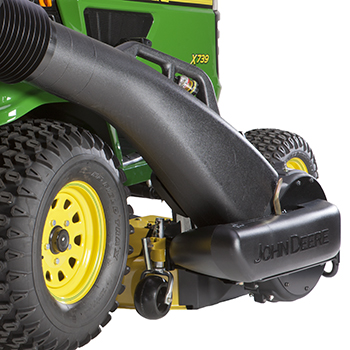 Power Flow blower and chute
Power Flow blower and chute
 7-bu (247-L), two-bag Power Flow hopper
7-bu (247-L), two-bag Power Flow hopper
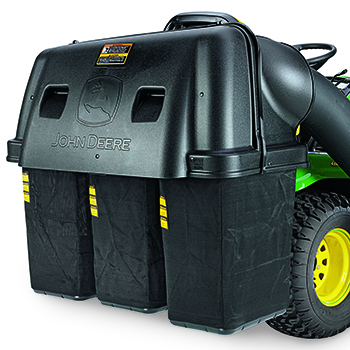 14-bu (500-L), three-bag Power Flow hopper
14-bu (500-L), three-bag Power Flow hopper
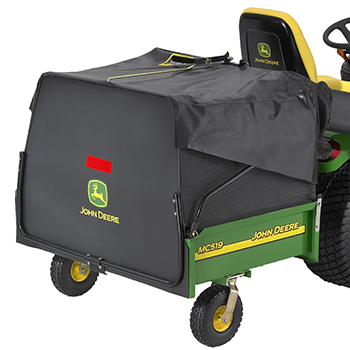 19-bu (670-L) MC519 Power Flow cart
19-bu (670-L) MC519 Power Flow cart
The 48-in. (122-cm) Accel Deep™ (48A) Mower Deck, 48-in. (122-cm) Edge™ Xtra Mower,* and 54-in. (137-cm) and 60-in. (152-cm) Edge High Capacity (HC) Mowers use a high-performance Power Flow blower to collect material into a variety of material collection systems:
- 7-bu (247-L), two-bag Power Flow hopper
- 14-bu (493-L), three-bag Power Flow hopper
- 19-bu (670-L), MC519 Power Flow cart
Features are as follows:
- Blower is hinged to provide easy installation.
- Blower is easy to swing out for easy cleanout.
- Blower fan runs in a clockwise direction (viewed from the right side) to efficiently move material up the chute.
The Power Flow blower works well with either the standard mower blades or the mulching blades.
Each of the John Deere material collection systems has durable construction for long life in homeowner or commercial applications.
*NOTE: The three-bag, 14-bu (493-L) Power Flow is not compatible with a X729, X739, or X749 Tractor equipped with a 48X Mower Deck because the chute can contact the rear tire in a turn. However, it is compatible with the 48 Accel Deep (48A) Mower because the increased deck height and the height of its Power Flow blower housing lift the chute high enough to clear the wheel and fender with the three-bag hopper installed.
48-in. (122-cm) Accel Deep™ Mower Deck cuts clean and is versatile
 X730 Tractor with 48A Mower Deck
X730 Tractor with 48A Mower Deck
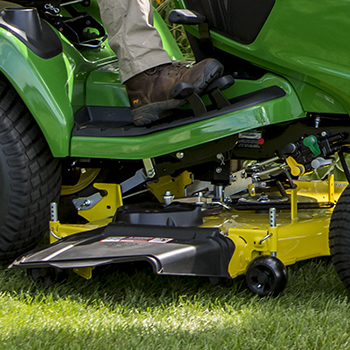 48A Mower Deck
48A Mower Deck
The 48-in. (122-cm) Accel Deep Deck uses the latest in three-spindle mowing technology to raise performance to a higher level:
- 10-gauge, 0.135-in. (3.4-mm) deck stamping for long life
- Deep, flat-top deck design to handle a large volume of material at faster mowing speeds
- Gives excellent cut quality and uniform discharge
- Easy to keep clean on top of and under the deck
- Stamped-steel design to eliminate sharp edges and corners where material can buildup and diminish mowing performance
- Resilient four-point mounting system suspends mower from tractor for a smooth and level cut
- Wide mower wheels easily adjusted just above ground level to help prevent scalping
- 0.25-in. (6.4-mm) cut-height increments allow mower to be set at the desired cut height
- Onboard deck-leveling system makes keeping mower properly adjusted easy
- Compatible with optional MulchControl™ mulching system
- Compatible with high-performance Power Flow™ material collection systems
- For use on X730, X734, X738, X739, X750, X754, and X758 Tractors
- Mower deck suspended from vehicle for smooth and level cut
- Adjustable mower wheels, positioned just above ground level, help prevent scalping.
Mower includes everything needed, including front draft arm assembly, for installation on any X700 Signature Series Tractor (model year 2013 and newer).
NOTE: The 9077M 48A Mower Deck requires a standard connect or auto connect attachment (similar to 54 HC and 60 HC Mower Decks). Unlike the 54 HC and 60 HC, the shaft drive 48A Mower is not a drive-over deck. Operators can rotate the mower wheels 90 degrees and roll the 48A Mower under an X700 Signature Series Tractor and utilize the auto connect to connect the power take-off (PTO) shaft.
Excellent cut quality
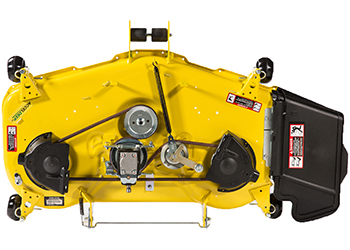 48A Mower top
48A Mower top
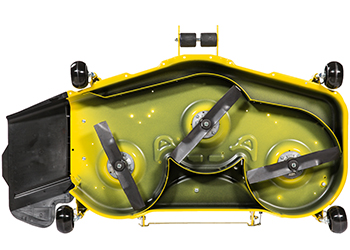 48A Mower underside
48A Mower underside
Deep mower-deck stamping gives excellent cut quality. It allows the cut and suspended material room to exit the deck without getting recut:
- Clean flow of material out of discharge area prevents cut material from interfering with cutting the incoming grass, making it possible for the blades to cut incoming material cleanly.
- Even in mulching mode, cut evenness is improved compared to other designs because the additional depth allows for continuous circulation, optimal recutting, and an even distribution of clippings.
Productivity - getting the job done fast
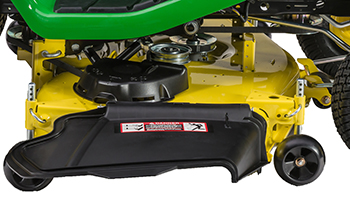 Right side of Accel Deep 48A Mower Deck (shown on X380 Tractor)
Right side of Accel Deep 48A Mower Deck (shown on X380 Tractor)
Deep mower-deck stamping gives high productivity, which gets the job done fast. It allows the cut and suspended material room to exit the deck quickly, reducing the amount of re-cutting so more power is available to process incoming grass:
- Greatly improves mowers capacity to maintain excellent mowing performance in difficult mowing conditions and at higher speeds
Large discharge opening is both high and wide to handle more material:
- Gives a smooth, even discharge of clippings at all mowing speeds
- Reduces the chance of plugging, especially important when operating in wet, thick, or dense grass and when bagging
- The 48A Power Flow blower has an inlet housing with over 50 percent greater area than the 48X Power Flow blower used on previous machines.
Cleanliness - for the mower and the operator
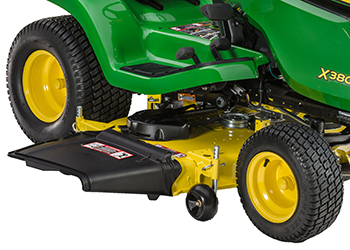 Accel Deep 48A Mower Deck (shown on X380 Tractor)
Accel Deep 48A Mower Deck (shown on X380 Tractor)
 Accel Deep 48A Mower Deck (shown on X300 Series Tractor)
Accel Deep 48A Mower Deck (shown on X300 Series Tractor)
The flat-top shape of the deck stamping is optimal for keeping itself and the operator clean:
- There are few places to catch and hold material on top and underneath the deck.
- Top of deck stays cleaner, reducing time and effort needed for cleaning and service
- Underside of deck is self-cleaning to maintain optimum performance without buildup of material to interfere with the flow of air and clippings
- Less need to clean and remove buildup of material from the underside of the deck
- The depth of the Accel Deep mower deck minimizes the amount of material that escapes from the front of the deck.
- Limited amount of material drifts onto the operator and mower deck.
- Even for material discharged out the chute, less re-cutting results in larger pieces that are less likely to end up on the operator.
- Mulching prevents the discharge of material completely and the MulchControl attachment makes mulching a practical solution for most mowing situations.
Cleaning a mower deck, both top and bottom, is one of the most frequent maintenance activities:
- The flat-top design reduces places for material to build up and makes material that does collect easy to remove.
 Mower wash port
Mower wash port
 Mower wash port with hose connector
Mower wash port with hose connector
A wash port is provided to make cleaning the underside of the mower deck easy.
- Hose connector is included with the mower deck.
Superior durability is designed in
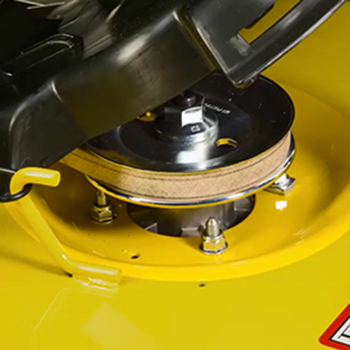 Spindle pocket with flip-up cover
Spindle pocket with flip-up cover
 Easy-to-adjust mower wheel and mower side reinforcement
Easy-to-adjust mower wheel and mower side reinforcement
The 48A Mower Deck has strong spindle pockets to keep the blades aligned, even after years of tough service:
- Ribs in the deck shell add strength where it is needed.
- The 48A has a 23 percent heavier overall weight than the Edge™ Xtra 48-in. (122-cm) mower deck used on previous machines.
Mower wheels are heavy duty:
- Provides greater strength and durability for longer, trouble-free life.
- Setting wheels to the correct height for the cutting height is quick and easy.
Low-tension belt-drive design reduces the side load on mower bearings for longer life.
The 48A Mower Deck features a 5/8-in. (16-mm) diameter solid-steel rod side bumper that provides extra strength and protection.
Dual-stage E-coat and powder-paint coatings provide extra protection from rust.
Versatility - easy to change between side discharge, mulch, and bagging modes
The 48A Mower is designed for maximum versatility, providing the greatest ease in changing from one mower discharge mode to another:
- With the optional MulchControl attachment installed (along with the special mulching blades), changing from side-discharge to mulching or vice versa is done with the simple flip of a lever.
- It is not necessary to change blades when changing discharge modes because the mulching blades are designed for side discharge as well.
- The Power Flow rear bagger can be used with the MulchControl attachment and blades by simply placing the MulchControl lever in the side-discharge position.
MulchControl option
The MulchControl attachment for the 48A Mower Deck makes mulching more practical for many mowing situations because it not only does an excellent job of mulching but it also allows the mower to be easily converted for times when it is more desirable to side discharge or collect the lawn material. Advantages of mulching grass clippings include:
- A beautiful looking lawn
- Grass clippings not blown onto the operator, driveways, or flower beds
- Less fertilizer use
- Elimination of the effort needed to dispose of clippings
How MulchControl works
 MulchControl baffle open
MulchControl baffle open
 MulchControl baffle closed
MulchControl baffle closed
MulchControl is an innovative, simple design that is easy to use and maintain:
- The MulchControl attachment includes baffles to control the flow of material under the deck.
- The MulchControl baffle, or divider, between the left and middle spindles is about half way down. The height is designed to balance the mulching and side-discharge modes.
- When the MulchControl baffle is open, the divider between the left and middle spindles passes a portion of the material to the discharge opening, along with the material from the middle and right spindle areas.
- When the MulchControl baffle is closed, the material stays within the deck and gets chopped into mulch and deposited in the turf.
 MulchControl baffle closed
MulchControl baffle closed
 MulchControl handle
MulchControl handle
- The MulchControl handle is located on top of the mower deck and used to open and close the discharge baffle.
- The operator is required to get off of the machine in order to engage or disengage mulch mode.
- Changing from mulching to side discharge or vice versa takes only a few seconds.
MulchControl is well-suited to the following mowing situations:
- Usually mulch, but side discharge when grass gets too long
- Usually side-discharge, but would like to be able to close the chute to control clippings
- Always mulch a main lawn, but often side discharge secondary lawns
- Bag clippings, but want to go farther before emptying bags
MulchControl puts the operator in control of the clippings. The operator can have all the benefits of mulching with the ability to easily change to side discharge or bagging when needed.
While in the side-discharge mode, MulchControl will still mulch about one third of the material. Therefore, the side-discharge mode is essentially a partial-mulch mode. This can be an advantage when side discharging or bagging, as it helps to reduce the amount of material being discharged. Other times this could work as a disadvantage:
- When cutting strong southern grasses, such as Zoysia and Bermuda
- When cutting in wet, high-growth conditions, such as those found in the Pacific Northwest United States
- When optimum bagging and lawn clean-up is desired
Power Flow material collection systems
 Optional 7-bu (247-L) two-bag Power Flow rear bagger shown
Optional 7-bu (247-L) two-bag Power Flow rear bagger shown
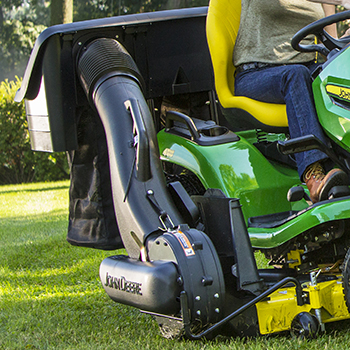 Power Flow blower
Power Flow blower
A variety of material collection systems is available for use with the Power Flow blower:
- 7-bu (247-L) two-bag Power Flow rear bagger
- 14-bu (493-L) three-bag Power Flow rear bagger
- 19-bu (670-L) MC519 Cart
The Power Flow blower and chute are easy to install. The Power Flow blower swings out for easy cleanout and cleanup.
The MowerPlus™ app helps maintain the tractor and lawn
 MowerPlus app screen
MowerPlus app screen
 MowerPlus app maintenance screen
MowerPlus app maintenance screen
Keep a John Deere riding lawn mower running its best and know how it mows with the John Deere MowerPlus app. Simply scan the lawn tractor’s barcode to get custom information. The app helps determine the best time to mow, communicates expert pre-mow tips, offers maintenance reminders, and provides walk-through guides.
Look for the MowerPlus app on the mobile device’s app store.
The app supports residential lawn equipment such as 100 Series, S240, X300, X500, X700, Z200 through Z600, and many similarly-sized older products. It does not presently support tractor models numbered 1000 and larger, such as 1025R.
NOTE: Some product image variation may exist.
Features
Engine is smooth running and reliable V-twin air-cooled design
 Smooth-running V-twin engine
Smooth-running V-twin engine

The tractor is powered by a John Deere iTorque™ power system, a combination of engine features and an exclusive hood design providing superior lugging ability, even cooling, and durability. Key engine features include:
- 24 hp (17.9 kW)
- Large 726 cc displacement
- V-twin air-cooled design
- Excellent power and performance
- Smooth, quiet power
- Easy starts
- Quality features include:
- Cast-iron cylinder liners
- Overhead valves
- Full-pressure lubrication
- Replaceable oil filter
- Dual-stage air cleaner
- Solenoid-shift starter for easy starts, even in cold weather
Flywheel alternator
A flywheel alternator provides plenty of capacity to quickly recharge the battery and power electrical equipment, such as lights or a sprayer:
- 15-amp capacity
- Regulated to keep the battery at a full charge, without risk of overcharging
Fuel tank has a large, 4.4-U.S. gal. (16.6-L) capacity
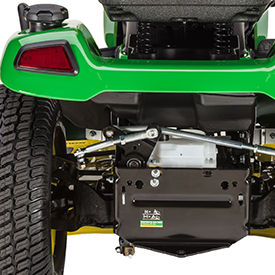 Fuel tank
Fuel tank
Quality fuel system components enhance performance and convenience:
- Large, 4.4-U.S. gal. (16.6-L) capacity
- Wide, 3-in. (7.6-cm) diameter fuel tank filler opening
- Located on the left fender
- Makes adding fuel easy and helps eliminate spillage
- Sealed and tethered fuel cap
- Reduced fuel vapor loss
- Less chance of losing fuel cap
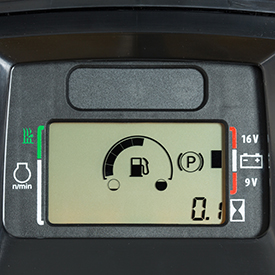 Convenient dash-mounted fuel gauge
Convenient dash-mounted fuel gauge
- Automotive-style fuel gauge on the dash
- Easy to read from tractor seat
- Reduces likelihood of running out of fuel
- Eliminates unnecessary stops to refill
The 54-in. (137-cm) Accel Deep™ (54A) Mower Deck cuts clean and is versatile
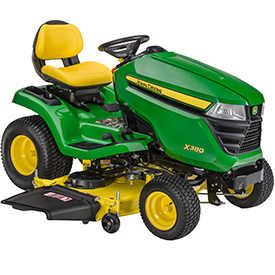 X394 with Accel Deep 54A Mower
X394 with Accel Deep 54A Mower
 Accel Deep 54A Mower
Accel Deep 54A Mower
The 54-in. (137-cm) Accel Deep Deck uses the latest in three-spindle mowing technology to raise performance to a higher level:
- 10-gauge, 0.135-in. (3.4-mm) deck stamping for long life
- Deep, flat-top deck design to handle a large volume of material at faster mowing speeds
- Gives excellent cut quality and uniform discharge
- Easy to keep clean on top of and under the deck
- Resilient four-point mounting system suspends mower from tractor for a smooth and level cut
- Wide mower wheels easily adjusted just above ground level to help prevent scalping
- 0.25-in. (6.4-mm) cut-height increments allow mower to be set at the desired cut height
- Onboard deck-leveling system makes keeping mower properly adjusted easy
- Compatible with optional MulchControl™ mulching system
- Compatible with high-performance Power Flow™ material collection systems
- For use on X380, X384, X390, X394, X570, X580, X584, and model year 2016 X590 Tractors
The 54-in. (137-cm) Accel Deep Mower Deck is a stamped-steel, deep, flat-top design that delivers excellent cut quality, productivity, cleanliness, durability, and versatility. Optimal performance and dispersion of clippings is provided, even at faster mowing speeds:
- 4.83-in. (12.3-cm) depth throughout the entire deck shell for optimum mowing, mulching, and bagging performance
- Optional lever-action or electric one-touch MulchControl attachment provides superior mulching performance and versatility.
- Stamped-steel design eliminates sharp edges and corners where material can build up and diminish mowing performance
- Mower deck is suspended from the vehicle for a smooth and level cut
- Adjustable mower wheels, positioned just above ground level, help reduce scalping
Excellent cut quality
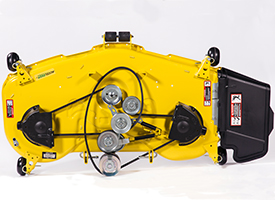 54A Mower top
54A Mower top
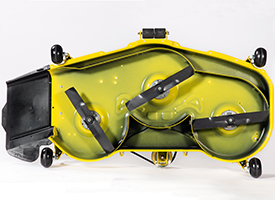 54A Mower underside
54A Mower underside
Deep mower-deck stamping gives excellent cut quality. It allows the cut and suspended material room to exit the deck without getting recut:
- Reducing the amount of re-cutting enables more power to be used to cut incoming grass, which greatly improves mower capacity.
- Helps maintain excellent cut quality at faster mowing speeds
- Clean flow of material out of discharge area prevents cut material from interfering with cutting the incoming grass, making it possible for the blades to cut incoming material cleanly.
- Even in mulching mode, cut evenness is improved compared to other designs because the additional depth allows for continuous circulation, optimal re-cutting, and an even distribution of clippings.
Productivity - getting the job done fast
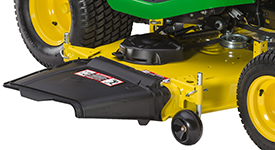 Right side of Accel Deep 54A Mower Deck
Right side of Accel Deep 54A Mower Deck
Deep mower-deck stamping gives high productivity, which gets the job done fast. It allows the cut and suspended material room to exit the deck quickly, reducing the amount of re-cutting so more power is available to process incoming grass:
- Greatly improves mowers capacity to maintain excellent mowing performance in difficult mowing conditions and at higher speeds
Large discharge opening is both high and wide to handle more material:
- Gives a smooth, even discharge of clippings at all mowing speeds
- Reduces the chance of plugging, especially important when operating in wet, thick, or dense grass and when bagging
- The 54A Power Flow blower has an inlet housing with over 20 percent greater area than the 54X Power Flow blower used on previous machines.
Cleanliness - for the mower and the operator
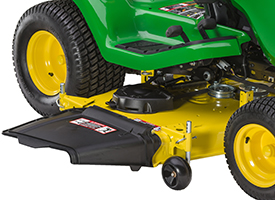 Accel Deep 54A Mower Deck
Accel Deep 54A Mower Deck
 Accel Deep 54A Mower Deck
Accel Deep 54A Mower Deck
The flat-top shape of the deck stamping is optimal for keeping itself and the operator clean:
- There are few places to catch and hold material on top and underneath the deck.
- Top of deck stays cleaner, reducing time and effort needed for cleaning and service
- Underside of deck is self-cleaning to maintain optimum performance without build-up of material to interfere with the flow of air and clippings
- Less need to clean and remove build-up of material from underside deck
- The depth of the Accel Deep mower deck minimizes the amount of material that escapes from the front of the deck:
- Limited amount of material to drift onto the operator and mower deck
- Even for material discharged out the chute, less re-cutting results in larger pieces that are less likely to end up on the operator
- Mulching prevents the discharge of material completely and a MulchControl attachment makes mulching a practical solution for most mowing situations.
Cleaning a mower deck, both top and bottom, is one of the most frequent maintenance activities:
- The flat-top design reduces places for material to build up and makes material that does collect easy to remove.
 Mower wash port
Mower wash port
 Mower wash port with hose connector
Mower wash port with hose connector
A wash port is provided to make cleaning the underside of the mower deck easy.
- Hose connector is included with the mower deck.
How MulchControl works
 MulchControl baffle open
MulchControl baffle open
 MulchControl baffle closed
MulchControl baffle closed
MulchControl is an innovative, simple design that is easy to use and maintain:
- The MulchControl attachment includes baffles to control the flow of material under the deck.
- The MulchControl baffle, or divider, between the left and middle spindles is about half way down. The height is designed to balance the mulch and side-discharge modes.
- When the MulchControl baffle is open, the divider between the left and middle spindles passes a portion of the material to the discharge opening, along with the material from the middle and right spindle areas.
- When the MulchControl baffle is closed, the material stays within the deck and gets chopped into mulch and deposited in the turf.
Superior durability is designed in
 Spindle pocket with flip-up cover
Spindle pocket with flip-up cover
 Easy-to-adjust mower wheel and mower side reinforcement
Easy-to-adjust mower wheel and mower side reinforcement
The 54A Mower Deck has strong spindle pockets, to keep the blades aligned, even after years of tough service:
- Ribs in the deck shell add strength where it is needed.
- The 54A has a 3 percent heavier overall weight than the Edge™ Xtra 54-in. (137-cm) mower deck used on previous machines.
Mower wheels are heavy duty:
- Provides greater strength and durability for longer, trouble-free life.
- Setting wheels to the correct height for the cutting height quick and easy.
Low-tension belt-drive design reduces the side load on engine lower bearings and mower deck bearings for longer life.
The 54A Mower Deck features a 5/8-in. (16-mm) diameter solid-steel rod side bumper that provides extra strength and protection.
Dual-stage E-coat and powder-paint coatings provide extra protection from rust.
Versatility - easy to change between side discharge, mulch, and bagging modes
The 54A Mower is designed for maximum versatility, providing the greatest ease in changing from one mower discharge mode to another:
- With an optional MulchControl attachment installed (along with the special mulching blades), changing from mulch mode to side discharge mode or vice versa is done with the simple flip of a lever or touch of an electric switch.
- The Power Flow rear bagger can be used with the MulchControl attachment and blades installed by simply using the MulchControl lever or electric one-touch switch to move the MulchControl baffle to the side-discharge position.
MulchControl option
A MulchControl attachment for the 54A Mower Deck makes mulching more practical for many mowing situations because it not only does an excellent job of mulching but it also allows the mower to be easily converted for times when it is more desirable to side discharge or collect the lawn material. Advantages of mulching grass clippings include:
- A beautiful looking lawn
- Grass clippings not blown onto the operator, driveways, or flower beds
- Less fertilizer use
- Elimination of the effort needed to dispose of clippings
 MulchControl handle
MulchControl handle
 Electric one-touch MulchControl switch
Electric one-touch MulchControl switch
- For the lever-action MulchControl attachment, the MulchControl lever on top of the mower deck is used to engage or disengage mulch mode.
- The operator is required to get off of the tractor in order to engage or disengage mulch mode with the lever-action system.
- For the electric one-touch MulchControl attachment, the electric switch on the tractor dash is used to engage or disengage mulch mode.
- Changing from mulch mode to side discharge mode or vice versa takes only a few seconds.
MulchControl is well-suited to the following mowing situations:
- Usually mulch, but side discharge when grass gets too long
- Usually side-discharge, but would like to be able to close the chute to control clippings
- Always mulch a main lawn, but often side discharge secondary lawns
- Bag clippings, but want to go farther before emptying bags
MulchControl puts the operator in control of the clippings. The operator can have all the benefits of mulching with the ability to easily change to side discharging or bagging when needed.
While in the side-discharge mode, MulchControl will still mulch about one third of the material. Therefore, the side-discharge mode is essentially a partial-mulch mode. This can be an advantage when side discharging or bagging, as it helps to reduce the amount of material being discharged. Other times this could work as a disadvantage:
- When cutting strong southern grasses, such as Zoysia and Bermuda
- When cutting in wet, high-growth conditions, such as those found in the Pacific Northwest United States
- When optimum bagging and lawn clean-up is desired
7-bu (247-L) Power Flow rear bagger
 Optional 7-bu (247-L) rear bagger
Optional 7-bu (247-L) rear bagger
 Power Flow blower
Power Flow blower
An optional 7-bu (247-L) rear bagger material collection system (MCS) is available. It provides an efficient means of collecting grass clippings and leaves:
- The Power Flow blower and chute are easy to install. The Power Flow blower swings out for easy cleanout and cleanup.
- The hopper design provides modern styling, great bagging performance, cleaner operation, and easy-to-empty bags:
- 7-bu (247-L) capacity
- Easy-to-attach Power Flow blower (ordered separately)
- Easy-to-attach chute (ordered separately)
- Air exhaust duct
- Convenient spring-latch
- Airflow fill indicator
- Quik-Tatch mounting
- Sealed hopper top
- Loose-knit bags available
Larger 14-bu (493-L) and 19-bu (670-L) MCS are available, in addition to the 7-bu (247-L) MCS, for specific X300 and X500 Series Tractor models.
Four-year or 500-hour bumper-to-bumper warranty is standard
An exclusive 4-year or 500-hour (whichever comes first), single-source, bumper-to-bumper warranty* is standard for all John Deere X500 Series Tractors.
- The warranty is hassle free, with one company handling all of the paperwork.
- Premium features of X500 Series Tractors allow for this longer warranty period, with more coverage than comparable tractors.
*Term limited to years or hours used, whichever comes first, and varies by model. See the LIMITED WARRANTY FOR NEW JOHN DEERE TURF AND UTILITY EQUIPMENT at JohnDeere.com or JohnDeere.ca/TUWarranty for details.
Hydrostatic transaxle has traction assist
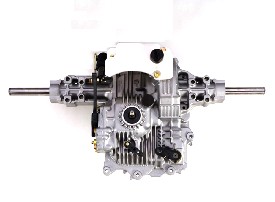 Hydrostatic transaxle
Hydrostatic transaxle
 Piston-type rotating groups
Piston-type rotating groups
The integrated hydrostatic transaxle (IHT) encloses the hydrostatic pump and motor rotating groups in the same housing with the differential and axle housing:
- Very efficient piston-type design
- Fewer sealing surfaces to minimize potential for leakage
When combined with the foot controls, the hydrostatic transmission functions similarly to that of an automatic transmission in an automobile, so the term automatic is often used to describe it.
Key features of the drive system are as follows:
- Large pump and motor rotating groups for long life and efficient operation
- Full-length axle housings to support heavy loads
- Twin Touch™ foot control for easy and precise change of speed and direction
- Internal wet-disk brakes for long life and consistent operation. Brake interlock system that returns the foot control pedals to neutral during panic stops.
- Return mechanism that closes the freewheeling valve when the brake pedal is depressed to start the engine
- Replaceable oil filter for extra protection for tractors equipped with hydraulic lift and steering
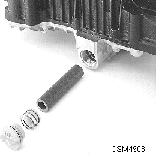 Replaceable filter (X580, X584, X590)
Replaceable filter (X580, X584, X590)
Standard cruise control
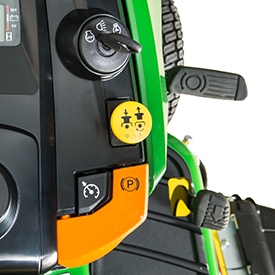 Cruise control
Cruise control
Cruise control is standard equipment:
- Maintains a set tractor ground speed for mowing large areas or when driving the tractor from one location to another.
- Convenient, easy-to-use button to activate cruise control function.
- Release cruise control with brake pedal or forward Twin Touch™ foot pedal
Traction assist (differential lock)
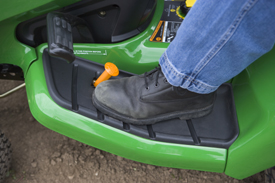 Traction assist control
Traction assist control
Traction assist is standard equipment:
- Traction assist supplies positive power to both drive wheels for increased traction.
- Foot-operated traction assist control is convenient for the operator to use, when needed.
Lever-action or electric one-touch MulchControl™ options are available for extra mowing convenience
 Lever-action MulchContol lever
Lever-action MulchContol lever
 Electric one-touch MulchControl switch
Electric one-touch MulchControl switch
Lever-action or electric one-touch MulchControl attachment is available for Accel Deep™ 42-in. (107-cm) (42A), 48-in. (122-cm) (48A), and 54-in. (137-cm) (54A) Mower Decks used on X300 and X500 Select Series™ Tractors.
MulchControl advantages and benefits
MulchControl enhances versatility and productivity. A mower deck equipped with MulchControl not only does an excellent job of mowing and mulching, but it can also be quickly converted from side discharging to mulching or vice versa:
- In mulch mode, it controls clippings dispersion in unwanted areas (driveways, landscape beds, near buildings, windows, parking lots, etc.).
- Reduces cleanup time needed to dispose of clippings.
- Reduces the amount of material entering a material collection system because, even in the side discharge mode, MulchControl will mulch about one third of the material due to the additional baffles under the mower deck and the unique design of the mulching blades.
Electric MulchControl has the additional advantage of being controlled from the tractor seat by a switch on the dash to operate an electric actuator that moves the baffle to close off the discharge area of the mower deck.
 Electric one-touch MulchControl switch
Electric one-touch MulchControl switch
 Electric one-touch MulchControl actuator
Electric one-touch MulchControl actuator
- Operators can convert between modes without interrupting the mowing process, making it practical to change between modes as conditions require.
- When approaching clean areas like driveways or flowerbeds where clippings would be undesirable
- When a breeze might blow clippings back onto the operator
- For side discharge mowing only the areas of the property where grass is too thick for mulching
- With 48A and 54A Mower Decks, for collecting only the areas of the property where grass is too tall or thick for mulching
- With 48A and 54A Mower Decks, the MulchControl baffle can be opened or closed with the Power Flow™ blower installed. The Power Flow blower will run without material when the baffle is closed.
- Models equipped with a 42A Mower Deck require a MulchControl baffle be removed to install the bagger chute; see 42A Mower Deck versatility explanation for more information.
- Changing from one mode to the other takes only a few seconds.
How MulchControl works
A mower equipped with a MulchControl attachment delivers unprecedented levels of productivity and versatility. The operator has the ability to quickly change between side discharging and mulching. A heavy-duty baffle opens and closes to convert the mower from side discharge mode to mulch mode or vice versa.
 MulchControl baffle open (similar mower deck shown)
MulchControl baffle open (similar mower deck shown)
 MulchControl baffle closed (similar mower deck shown)
MulchControl baffle closed (similar mower deck shown)
MulchControl is an innovative, simple design that is easy to use and maintain:
- The MulchControl attachment includes baffles to control the flow of material under the deck.
- When the MulchControl baffle is open, most of the material flows freely out the discharge deflector or into a material collection system.
- When the MulchControl baffle is closed, material stays within the deck and gets chopped into mulch and deposited in the turf.
MulchControl is well-suited to the following mowing situations:
- For operators who usually mulch, but side discharge when grass gets too long
- For operators who usually side discharge, but would like to be able to close the chute to control clippings in some areas
- For operators who always mulch a main lawn, but often side discharge secondary lawns
- For operators who collect clippings, but want to go farther before emptying the material collection system
MulchControl puts the operator in control of the clippings. The operator can have all the benefits of mulching with the ability to easily change to side discharging when desired.
Advantages of MulchControl include:
- Performance is improved.
- Mulching is beneficial because it returns the clippings to the ground as fertilizer, which promotes lawn growth.
- Clippings are much smaller, which allows them to fall into the grass and be removed from view.
- Unsightly grass clippings are not blown onto driveways or into flower beds.
- Fertilizer use is reduced and provides associated environmental benefits.
- Uptime is increased.
- Operators can convert quickly between modes, making it possible to change between mulching and side discharging as conditions require.
- Mulching heavy, thick material can significantly reduce mower productivity. The ability to switch from mulch to side discharge mode ensures productivity, especially in grass too tall or thick to mulch effectively.
- Cost of operation is reduced.
- Controlling clipping dispersion reduces cleanup time.
MulchControl limitations
While in the side discharge mode, MulchControl will still mulch about one third of the material. Therefore, the side discharge mode is essentially a partial mulch mode. This can be an advantage when side discharging or bagging, as it helps to reduce the amount of material being discharged. Other times this could work as a disadvantage:
- When cutting strong southern grasses, such as Zoysia and Bermuda
- When cutting in wet, high growth conditions, such as those found in the Pacific Northwest United States
- When optimum bagging and lawn cleanup is desired
- 42A Mower Deck requires a MulchControl baffle be removed to install the bagger chute
Lever-action MulchControl attachments
| Attachment number | Description | Applications |
| BM24794 | 42A MulchControl (lever action) | X300 Series Tractors, Z300 Series ZTrak™ Mowers |
| BM24993 | 48A MulchControl (lever action) | X300 and X500 Series Tractors, Z300 and Z500 Series ZTrak Mowers |
| BM24994 | 54A MulchControl (lever action) | X300 and X500 Series Tractors, Z300 and Z500 Series ZTrak Mowers |
Electric one-touch MulchControl attachments
| Attachment number | Description | Applications |
| BUC10164 | 42A electric one-touch MulchControl | X300 Series Tractors* |
| BUC10165 | 48A electric one-touch MulchControl | X300 and X500 Series Tractors* |
| BUC10166 | 54A electric one-touch MulchControl | X300 and X500 Series Tractors* |
* NOTE: Model year 2016-2017 X300 and X500 Series Tractors (X300 serial number 10,001-50,000 and X500 serial number 110,001-130,000) require replacing the tractor wiring harness and dash panel to use an electric MulchControl attachment.
MulchControl compatibility
Each MulchControl attachment includes everything needed: baffles and mulch blades for all attachments, and the actuator, wiring, and switches for the electric one-touch attachments.
Snow removal and yard care is a strength of lawn tractors
 X590 Tractor shown with optional front blade and weather enclosure
X590 Tractor shown with optional front blade and weather enclosure
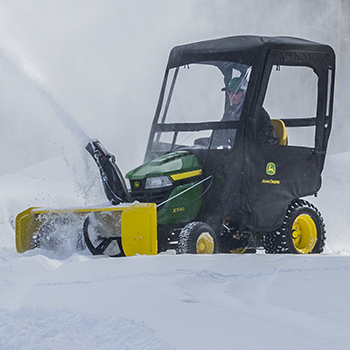 X590 Tractor shown with optional snow blower and weather enclosure
X590 Tractor shown with optional snow blower and weather enclosure
An advantage of lawn tractors is their ability to use attachments for snow removal and other yard-care chores. Lawn tractor owners can add a John Deere snow blower or front blade to make quick work of moving snow whenever the need arises. Weather enclosure and tire-chain attachments add comfort and performance.
Equipment available for snow removal includes:
- 44-in. (112-cm) Snow Blower for X570 Tractor
- 47-in. (119-cm) Snow Blower for X580, X584, and X590 Tractors
- 48-in. (122-cm) Front Blade
- Tire chains or TerraGrip traction belts
- Weather enclosure
- Weights
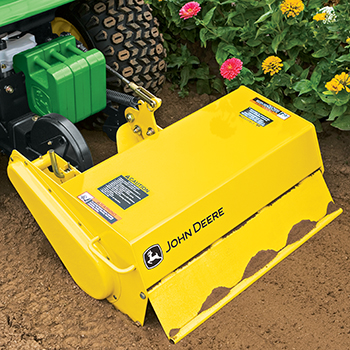 30-in. (76-cm) Mechanical Rotary Tiller
30-in. (76-cm) Mechanical Rotary Tiller
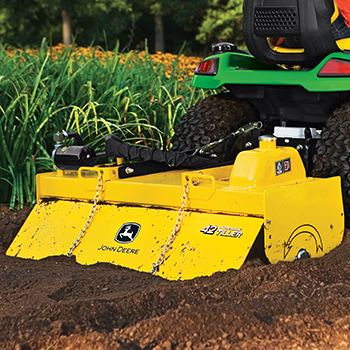 42-in. (107-cm) Hydraulic Rotary Tiller
42-in. (107-cm) Hydraulic Rotary Tiller
Rotary tillers are real time savers for preparing seedbeds, controlling weeds, and other tillage jobs.
Equipment available for tilling includes:
- 30-in. (76-cm) Mechanical Rotary Tiller for X570, X580, and X590 Tractors
- 42-in. (107-cm) Hydraulic Rotary Tiller for X580 and X590 Tractors
- The hydraulic tiller is quieter operating and has the unique ability to operate with either forward or reverse tine rotation.
- Weights
Steering is low-effort sector and pinion system
 X570 Tractor
X570 Tractor
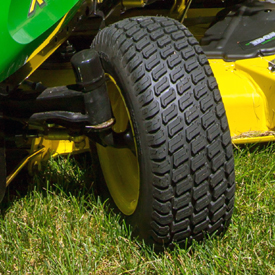 Tractor front wheel
Tractor front wheel
A heavy-duty sector and pinion steering system with quality bearings provides easy and precise control for the life of the tractor:
- Tight, 22-in. (56-cm) turning radius provides excellent maneuverability.
- Tight turning ability improves mowing efficiency.
Easy steering
Easy steering is important to give the operator an enjoyable mowing experience:
-
Larger, 14-in. (35.6-cm) diameter steering wheel improves leverage for easier turns.
-
Larger sector gear improves (increases) the steering ratio.
-
Higher steering ratio equals lower steering effort
-
-
Dual drag links help equalize steering loads and greatly reduce steering error.
-
Ball joints are provided on both ends of the steering tie rods.
-
Long steering arms improve the mechanical advantage of the steering system though the full range of motion.
-
Steering wheel/pinion gear shaft turns on a sealed ball bearing at the pinion gear.
-
Gives easy steering
-
Long steering system life
-
-
Sector gear pivots on a shaft rather than a bushing to ensure proper gear mesh and eliminate binding.
-
Upper and lower ends of the sector-gear shaft pivot on sealed ball bearings.
-
Reduce steering effort
-
Provide a smooth feel for the life of the tractor
-
-
Greaseable front steering spindles pivot on heat-treated bushings.
-
Reduce friction for easier steering
-
Improve wear over time
-
Control and display functions are easy to identify and convenient to use
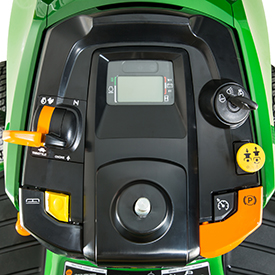 Controls and gauges (steering wheel removed)
Controls and gauges (steering wheel removed)
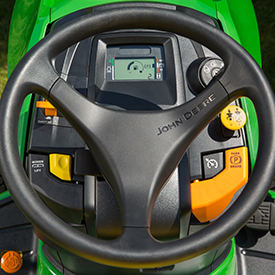 Dash (X590 Tractor shown with switch on to show display)
Dash (X590 Tractor shown with switch on to show display)
Controls
The contoured dash has clean, attractive styling and ergonomic controls for easy use:
- Controls are color-coded for easy identification by the operator.
- Controls are logically placed and easy to reach.
- The power take-off (PTO) switch allows the operator to get fingers underneath it, like a T-handle, to pull up for easy activation.
- The reverse implement option (RIO) switch is a yellow button.
- The latch control on foot-lift models and hydraulic-lift control on power-lift models and the park brake latch are pivot levers for low effort.
- Cruise control activation is handled by an automotive-style button.
- Separate engine speed and choke controls make starting and warming up the engine easier in cold weather.
- The choke lever is spring loaded to eliminate the chance the tractor will be unintentionally operated with the choke partially closed.
- Functional design of the throttle and choke controls provides good appearance and a comfortable feel.
Display panel
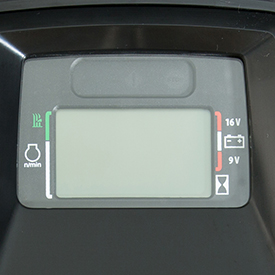 Display panel
Display panel
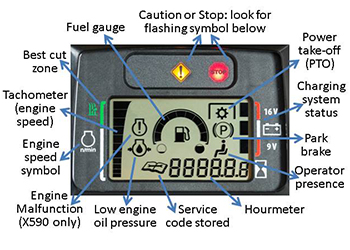 Display panel illustration with descriptions
Display panel illustration with descriptions
Instrument display has the look and feel of a modern automobile. A power-up sequence cycles lights and gauges to indicate they are working:
- Display features dark-cockpit design to minimize operator distractions.
- Display is back lit for night visibility.
- Night visibility is especially useful with snow blower use.
- Hour meter makes it easy to tell when oil changes and other maintenance should be performed.
- Electronic fuel gauge provides real-time fuel level information.
- A tachometer graphically displays engine speed.
- Target-zone graphics inform the operator of the engine speed range to use for best cut quality.
- An indicator tells the operator when the PTO is operating.
- Bright caution and stop lights capture the operator's attention when important information is on the instrument cluster.
- Damage can be prevented and repair costs reduced by addressing problems early.
- Operators are advised of what the problem is if they attempt to operate the mower with unsatisfied PTO, seat, or park brake interlocks.
- The indicators are also useful to identify the reasons the PTO or engine may have shut off when an interlock is unsatisfied.
- Operators are advised if battery voltage is low, normal, or excessive.
- The service indicator light illuminates to indicate a diagnostic error code is stored.
- On-board diagnostics provides trouble codes for use by trained technicians.
- For example, a technician will be able to test switch functionality and circuit continuity without tools.
- On-board diagnostics provides trouble codes for use by trained technicians.
Twin Touch™ foot control
 Twin Touch foot control
Twin Touch foot control
 Cruise control
Cruise control
Twin Touch foot pedals control the speed and direction of travel:
- Automotive-type accelerator control ensures easy operation.
- Operator can change direction without lifting foot off the platform.
- Large pedal surface gives superior operator comfort.
Cruise control
Cruise control is standard equipment:
- To engage, push the cruise-control button and hold until the foot is removed from the forward pedal.
- For emergency stop, the cruise control can be released by pushing on the brake pedal or the forward pedal.
Convenient hydraulic lift (X580, X584, X590)
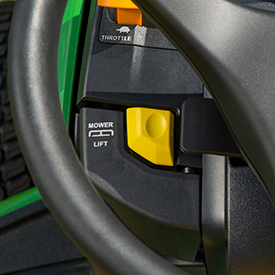 Hydraulic lift lever (X580, X584, X590)
Hydraulic lift lever (X580, X584, X590)
Convenient hydraulic lift lever makes raising and lowering the mower or implement easy:
- The hydraulic lift control lever is positioned on the dash near the steering wheel.
- Hydraulic lift provides quick, easy, and precise fingertip control of equipment.
- Implement float is built into the lift linkage.
Mower deck height adjustment
 Conveniently located mower deck height adjustment
Conveniently located mower deck height adjustment
 Onboard mower adjusting gauge and wrench
Onboard mower adjusting gauge and wrench
A rotary dial knob makes adjusting the mower cut height quick and easy:
- Mower cut height can be adjusted in 0.25-in. (6.4-mm) increments from 1 in. (2.5 cm) to 4 in. (10.2 cm).
- Mower deck returns to the same preset height each time it is lowered.
- Onboard deck-leveling gauge and Exact Adjust tool conveniently located in the storage compartment under the seat
- Used in conjunction with Exact Adjust ports for easy and accurate leveling of the mower deck for optimum mowing performance
 Deck-leveling gauge placed under deck
Deck-leveling gauge placed under deck
 Exact Adjust tool is used to level mower deck
Exact Adjust tool is used to level mower deck
Storage for the onboard deck-leveling gauge and the Exact Adjust tool is provided in the storage tray under the tractor’s seat:
- Exact Adjust ports allow for easy and accurate leveling of the mower deck for optimum mowing performance.
Deck-leveling gauge is placed at the appropriate location under the left rear, right rear, and front of the mower deck as the cut height is adjusted using the Exact Adjust tool and front draft arm adjusting nuts.
Foot pedal lift system (X570)
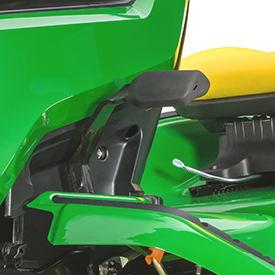 Foot pedal lift system (X570)
Foot pedal lift system (X570)
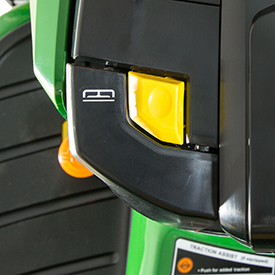 Foot-lift latch control
Foot-lift latch control
Pushing with the foot to raise the mower or implement is less strenuous for many operators:
- Easy-to-use raised-position lock operates similarly to the park brake lock.
- Foot pedal is out of the way and not likely to catch on bushes and tree limbs when mowing.
- Mower deck returns to the same preset height each time it is lowered.
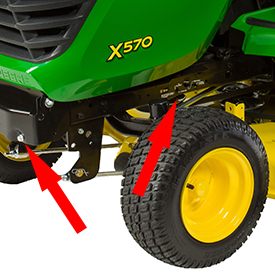 Lift-spring decals and bolt
Lift-spring decals and bolt
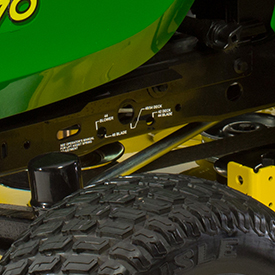 Lift-assist spring decal
Lift-assist spring decal
A lift-assist spring is provided on the tractor to minimize lift effort:
-
Lift effort can be easily adjusted by just turning a bolt located on the tractor front bumper for optimum performance, depending on the equipment used (mower, front blade, etc.).
-
Decals on the outside of the tractor frame indicate appropriate adjustment.
-
The mower will not be inadvertently locked in the raised position when mowing through ditches.
-
When installing or removing a mower or front equipment raised by the foot-lift system, spring tension may be removed from the connection points.
-
Pull rearward on the lift pedal and raise the lift latch to hold the pedal in the rearward position.
-
Parking brake control
 Parking brake
Parking brake
Depressing the brake pedal applies force to internal wet-disk brake (which provides excellent durability and long life) for safe stopping.
Parking brake control is conveniently located for easy access; holds brake pedal securely in locked position.
Electric power take-off (PTO) clutch is easy and convenient to use
 Electric PTO switch
Electric PTO switch
The heavy-duty electric PTO clutch is operated with a convenient dash-mounted switch.
Heavy-duty PTO clutch
 PTO clutch
PTO clutch
The PTO clutch is designed to operate through many on/off cycles.
RIO
 Reverse implement switch
Reverse implement switch
Using RIO
CAUTION: Children or bystanders may be injured by rotating blades. Before traveling forward or rearward:
- Carefully check the area around the machine.
- Disengage the mower before backing up.
NOTE: Operating the mower while backing up is strongly discouraged. RIO should be used only when operating another attachment or when the operator deems it necessary to reposition the machine with the mower engaged.
- Stop forward travel. Allow attachment to run.
- Look down and behind the machine to be sure that there are no bystanders.
- Push and hold in the reverse implement switch while depressing the reverse pedal slightly.
NOTE: If the attachment stops while positioning the machine, return mower engagement (PTO) switch to off position. Repeat this procedure from the beginning. - Release the reverse implement switch and reposition the machine as the machine begins to move rearward.
- Resume forward travel. The attachment should continue operating.
- Repeat procedure to position the machine again.
Frame is formed from heavy-duty steel and welded for reliability
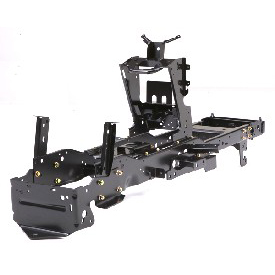 Heavy-duty welded frame
Heavy-duty welded frame
 Rear weight bracket/hitch
Rear weight bracket/hitch
The frame is made of heavy-duty formed steel, reinforced in critical areas and welded for even greater strength:
- Frame is formed from 12-gauge, 0.105-in. (2.66-mm) thick material.
- Rear hitch plate is formed from 0.25-in. (6.4-mm) steel and completes the frame assembly.
- Rear hitch plate can support up to four 42-lb (19-kg) Quik-Tatch weights.
- Optional front bumper for the X570 Tractor can support up to four 42-lb (19-kg) Quik-Tatch weights.
Front axle and wheel spindles are heavy duty
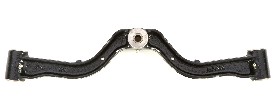 Cast-iron front axle
Cast-iron front axle
The front axle is made of nodular cast iron:
- Strong and shock resistant
- Will not yield under heavy loads or impact
Replaceable bushings are used at the center axle pivot and steering spindles:
- Provide excellent wear resistance
- Grease cavity between bushings maintains lubrication and easy steering between greasings
- Easy-to-service grease fittings at each spindle
Front steering spindles
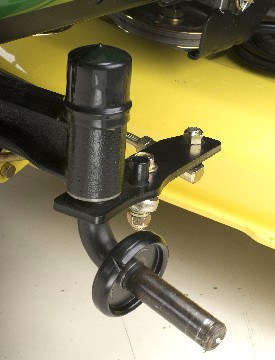 Steering spindle (X570 shown)
Steering spindle (X570 shown)
The front steering spindles are strong for long life:
- Have the strength to handle heavy implements
- 0.75-in. (19-mm) steering spindle diameter (X570)
- 1-in. (25.4-mm) steering spindle diameter (X580, X584, X590)
- Provide long life at bearing surfaces
- 0.75-in. (19-mm) diameter front wheel bearings (X570)
- 1-in. (25.4-mm) diameter front wheel bearings (X580, X584, X590)
- Sealed precision ball bearings at front wheels ensure long life and are maintenance free
Rear equipment-mounting system is heavy-duty and easy to use
 Rear equipment mounting system
Rear equipment mounting system
A heavy-duty equipment mounting system is used:
- Includes strong frame mounts with a combination of mounting holes in the tractor hitch plate that accept pins or shoulder bolts to support heavy rear-mounted equipment.
- Easily attach optional equipment to the tractor
- Can bear the load of heavy rear-mounted equipment, such as material collection systems
Modern styling is eye appealing and functional
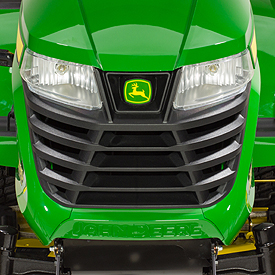 Attractive styling
Attractive styling
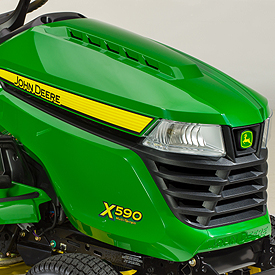 Side-hood vents
Side-hood vents
Smooth, rounded contours present a modern, styled appearance:
- Hood styling incorporates efficient full-length air-intake louvers on each side.
- Cooler engine operation
- Lower operator station sound levels
- Hot air is vented out the front grill, away from the operator.
- The fully enclosed hood is made of molded-in-color material.
- Reduces sound
- Will not rust or dent
- Distinctive grille and large, one-piece fender deck complete the styling package.
Versatility and premium features for great performance with larger equipment
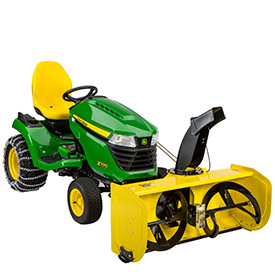 X590 show with 47-in. (119-cm) Snow Blower
X590 show with 47-in. (119-cm) Snow Blower
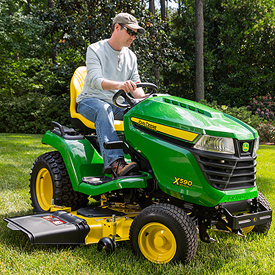 X590 Tractor shown
X590 Tractor shown
Premium features ensure the versatility of X500 Series Tractors:
- Heavy-duty welded-steel frame with integrated rear weight bracket
- Integrated front weight bracket (X580, X584, X590)
- Air-cooled John Deere iTorque™ power system
- Differential lock
- Convenient foot-pedal lift system (X570) or easy-to-use hydraulic lift (X580, X584, X590)
- Low-effort manual steering (X570) or power steering (X580, X584, X590)
- Five-position tilt steering wheel (X584, X590)
- Heavy-duty all-purpose (HDAP) rear tires (X580, X590)
- Accel Deep™ Mower Decks with optional MulchControl™ system
Two headlights give excellent visibility
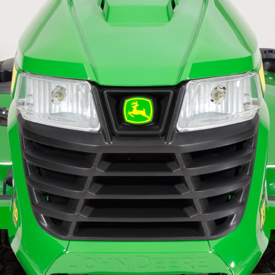 Quality headlights
Quality headlights
Headlights are standard equipment.
High-quality headlights make evening work easier and safer:
- Two 27-W bulbs provide excellent lighting for improved visibility during evening operation.
- A headlight position on the ignition switch makes it easy to operate the headlights.
- Headlights are designed to provide an optimum lighting pattern for mowing and snow removal.
Operator station is comfortable and convenient
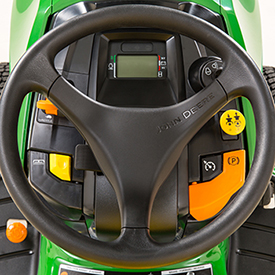 Dash controls are color coded for identification
Dash controls are color coded for identification
 Automotive-like dash display
Automotive-like dash display
The operator station is designed for operator comfort and convenience in operating all controls. The controls are easy to use and color coded for quick identification.
Comfortable seats
 15-in. (38-cm) open-back seat (X570, X580)
15-in. (38-cm) open-back seat (X570, X580)
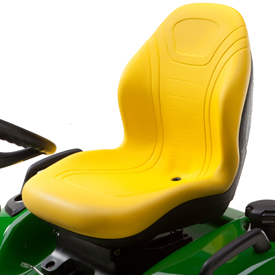 21-in. (53-cm) high-back seat (X584, X590)
21-in. (53-cm) high-back seat (X584, X590)
The 15-in. (38-cm) open-back seat (X570, X580) features distinctive styling and is designed for comfort:
- Open-back design allows air circulation to keep the operator's back cool and dry for a more comfortable ride.
- Hand grip at the top of the seat is conveniently located for use when tilting the seat up to protect it from the weather.
The 21-in. (53-cm) high-back seat (X584, X590) provides additional comfort and support for the operator.
Adjustable suspension
 Seat shown with optional storage pocket
Seat shown with optional storage pocket
The seat suspension is easily adjusted to make most any operator comfortable:
- 7 in. (18 cm) of seat travel allows the operator to be seated comfortably and operate the controls easily.
- Seat can be easily adjusted fore and aft by the operator while sitting on the seat (15 positions).
- Seat features a suspension that is easily adjusted for the operator's weight and height.
- Springs provide a smooth ride and will not bottom out.
- Spring position is adjustable for the operator's weight.
- Seat tilts forward to keep the seating surface out of the weather.
- Tilting the seat forward keeps moisture and the sun off the seat cushion for greater operator comfort.
- Optional storage pocket (X570, X580) provides a convenient storage area for gloves, etc.
Optional 21-in. (53.3-cm) professional two-piece seat, four-bar suspension, and slide
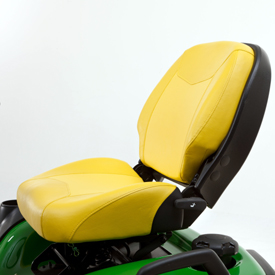 Seat has convenient tilt-back feature
Seat has convenient tilt-back feature
 Tilt-back seat control
Tilt-back seat control
The optional 21-in. (53.3-cm) professional two-piece seat, four-bar suspension, and slide shipped on Signature Series X700 Tractors is available as an upgrade seat and suspension for all X500 Multi-Terrain Tractors (model year 2006-). Key selling features for this seat include:
- Thick seat cushion for lasting comfort, even after a full day of use
- Back of seat can be angled to maximize operator comfort
- Convenient lever on the side of the seat unlocks back of seat to allow positioning
- Four-bar suspension and slide are included for extra comfort and bolt to the tractors fender-deck mounting holes
- BM24426 armrest attachment available as a field-installed option
Optional armrest attachment
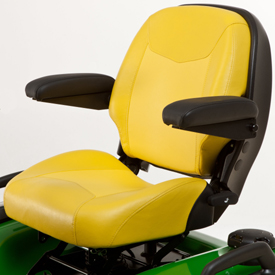 Adjustable armrest option
Adjustable armrest option
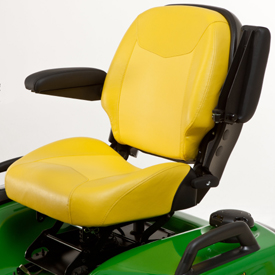 Left armrest in raised position
Left armrest in raised position
Armrests increase operator support and comfort, thus reducing fatigue and improving productivity, especially when mowing for extended periods of time. Armrests are adjustable to suit the operator. This armrest attachment is designed for the optional 21-in. (53.3-cm) professional two-piece seat.
Tilt steering wheel (X584, X590)
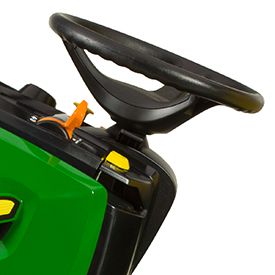 Tilt steering wheel (lowest position)
Tilt steering wheel (lowest position)
 Tilt steering wheel (highest position)
Tilt steering wheel (highest position)
- Five steering-wheel positions allow the operator to select the most comfortable setting (X584, X590).
Rubber foot pads
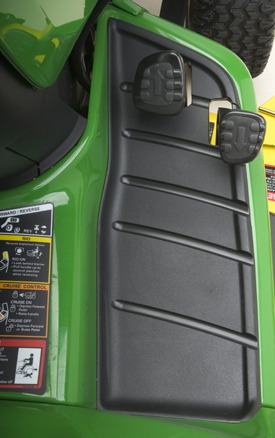 Rubber foot pads
Rubber foot pads
Rubber foot pads make the operator more comfortable:
- Help insulate operator's feet from vibration
- Attractive styling
- Long-lasting wear surface
- Reduce chance of slippage, even with wet surface
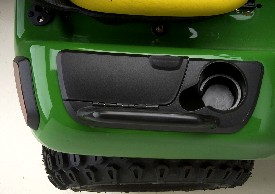 Cup holder, toolbox, and fender handle
Cup holder, toolbox, and fender handle
A cup holder and covered toolbox are conveniently located on the fender next to the operator's seat.
Handles on each fender are useful when getting on and off the tractor.
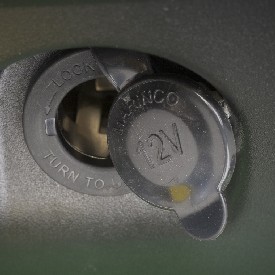 Standard 12-V outlet
Standard 12-V outlet
A 12-V outlet is standard equipment and provides a convenient plug-in for electrical equipment.
 Illustration of fast connector location
Illustration of fast connector location
A mid-vehicle 12-V fast connector, located under the tractor’s fuse box, is included as standard equipment to reduce initial installation time for some attachments that operate on 12-V power from the tractor:
- The four-cavity connector includes battery, ground, and key switch terminals and is turned on and off with the ignition switch.
Serviceability is convenient with easy-open hood
 One-piece hood is easy to open
One-piece hood is easy to open
 Service interval decal located under hood
Service interval decal located under hood
The one-piece hood opens easily to permit checking and servicing the engine:
- Important service points are located within easy reach.
- A service-interval decal is provided inside the tractor hood for convenience when servicing the tractor.
- The high-quality engine used in the X500 Series does not require an 8-hour oil and filter change because improvements in manufacturing processes and quality of parts, components, and oils have eliminated the need for the short interval oil change requirement.
 Easy-to-service engine fuel and oil filters
Easy-to-service engine fuel and oil filters
The engine fuel and oil filters, the oil check/fill tube, and the oil drain tube are exposed for serviceability when the hood is opened.
Exact Adjust ports and onboard deck-leveling tools make precise deck adjustments easy
 Deck-leveling gauge and hex adjusting tool stored under tractor seat
Deck-leveling gauge and hex adjusting tool stored under tractor seat
 Exact Adjust access holes
Exact Adjust access holes
A mower deck must be level side-to-side and properly adjusted front-to-rear to give the best cutting performance. A removable onboard deck-leveling gauge and a hex-key tool are provided to make adjustment easy. They are securely stored under the tractor seat.
Exact Adjust leveling ports are provided on each side of the operator platform above the mower-level adjusting bolts. With the hex-shaped tool, they provide convenient access to allow quick and easy adjustment of the mower for the best-cut quality of cut.
The Exact Adjust feature is standard on all Select Series™ X300 and X500 Tractors:
- There is no need to reach under the fender deck while making the mower-level adjustment.
- Onboard deck-leveling gauge, Exact Adjust ports, and the hex tool work together.
- Level the mower deck side to side
- Set the correct amount of rake (front-to-back deck orientation)
- Calibrate the cutting height to the cut-height adjusting knob setting
- Exact Adjust simplifies leveling the mower deck if equipped with a Power Flow™ blower.
- To give the best cut, mower level should be adjusted if alternately mowing with and without blower installed. The Exact Adjust feature makes this easy.
 Deck-leveling tool placed under deck
Deck-leveling tool placed under deck
 Using included ball-hex tool to level mower deck
Using included ball-hex tool to level mower deck
Consult the operator's manual for the correct adjusting procedures for each tractor model. Basic adjusting steps to properly level the mower deck include:
- Park the tractor on a level surface.
- Inflate tires to the correct pressure.
- Consult the label for the cutting-height knob that is located on the console of the machine. This label shows deck-leveling position and location of deck-leveling adjustment points.
 Cut height adjusting knob
Cut height adjusting knob
- Set mower cutting-height knob to the correct deck-leveling position.
- For X300 models, use position 2.75
- For all other models, use position 2.5
- Adjust mower wheels as necessary so they do not contact the ground surface.
- Remove the onboard deck-leveling gauge that is located under the seat.
- Using the Exact Adjust ports and tool, adjust mower deck side-to-side level so the deck-leveling gauge just slips under the left and right lower deck rim at the designated adjustment points. The location of adjustment points will vary slightly between decks.
- Left- and right-rear adjustment points are under the deck rim near the rear mower wheels, if equipped.
- Adjust mower deck front-to-back level, if necessary.
- Loosen rear nuts equally on each side of front lift rod.
- Turn front nut equally on each side clockwise to raise front of mower or counterclockwise to lower it until gauge just slips under the front adjustment point.
- Tighten rear nuts after adjustment is complete.
- Return the gauge to its storage position.
NOTE: The adjusting tool supplied with the tractor is an 8-mm ball-hex key, part number M162737. The rounded end allows for some misalignment with the bolt as the deck is adjusted.
The MowerPlus™ app helps maintain the tractor and lawn
 MowerPlus app screen
MowerPlus app screen
 MowerPlus app maintenance screen
MowerPlus app maintenance screen
Keep a John Deere riding lawn mower running its best and know how it mows with the John Deere MowerPlus app. Simply scan the lawn tractor’s barcode to get custom information. The app helps determine the best time to mow, communicates expert pre-mow tips, offers maintenance reminders, and provides walk-through guides.
Look for the MowerPlus app on the mobile device’s app store.
The app supports residential lawn equipment such as 100 Series, S240, X300, X500, X700, Z200 through Z600, and many similarly-sized older products. It does not presently support tractor models numbered 1000 and larger, such as 1025R.
NOTE: Some product image variation may exist.
Also available is the John Deere MowerPlus smart connector (sold separately).
 Smart connector
Smart connector
The John Deere MowerPlus smart connector wirelessly links a Select Series™ X300 or X500 Tractor to the MowerPlus app on a mobile device. The smart connector transmits engine usage to the app, making it easy to track maintenance intervals. It also transmits the fuel level to the app—when thinking ahead about Saturday morning mowing, the operator can make sure the tractor is fueled and ready to go.
Features
Excellent residue-handling capability in primary tillage at all residue levels
 915 V-Ripper
915 V-Ripper
The 915 V-Ripper has excellent residue-handling capability in primary tillage at all residue levels. At higher levels, coulters may be required to minimize plugging.
Typical percentage of residue cover remaining from the 915 are listed as follows.
NOTE: The percentage do not take into account variables such as the condition of the residue, speed, and soil type.
| 508-mm (20-in.) models | ||
Starting |
Remaining |
Remaining |
100 |
60 |
50 |
90 |
55 |
45 |
80 |
50 |
40 |
70 |
40 |
35 |
60 |
35 |
30 |
50 |
30 |
25 |
40 |
25 |
20 |
| 762-mm (30-in.) models | ||
Starting |
Remaining |
Remaining |
100 |
60 |
50 |
90 |
55 |
45 |
80 |
50 |
40 |
70 |
40 |
35 |
60 |
35 |
30 |
50 |
30 |
25 |
40 |
25 |
20 |
*Non-fragile residue includes crops like corn, sorghum, wheat (more than 45 bu).
**Fragile residue includes crops like soybeans, edible beans, peas, wheat, (under 45 bu), sunflower, peanuts, cotton.
Multiple frame sizes available
 Five-standard 915 V-Ripper
Five-standard 915 V-Ripper
The frame is available in 127-mm x 178-mm (5-in. x 7-in.) and 178-mm x 178-mm (7-in. x 7-in.) sizes.
The frame design of the 915 V-Ripper positions standards in a true V-pattern:
- Reduces plugging in higher levels of residue
- Gives the center standard a leading-edge shattering effect that reduces horsepower requirements over straight bar rippers
 Strong 10-mm (3/8-in.) wall mainframe
Strong 10-mm (3/8-in.) wall mainframe
127-mm x 178-mm (5-in. x 7-in.) frame models have 10-mm (3/8-in.) thick walls:
- Ideal for tractors up to 225 PTO horsepower (hp) and 4WD tractors up to 250 engine hp
- Available in five- or seven-standard models
- Parking stands are included in base equipment
 Heavy-duty 13-mm (1/2-in.) wall mainframe
Heavy-duty 13-mm (1/2-in.) wall mainframe
178-mm x 178-mm (7-in. x 7-in.) frame models have 13-mm (1/2-in.) thick walls:
- Ideal for tractors with up to 360 engine hp
- Basic frame can be equipped with seven or nine standards
- Bolt-on extensions can be added to allow 11 or 13 standards
- Parking stands are optional equipment
NOTE:
- 11-standard size is limited to 508-mm and 635-mm (20-in. and 25-in.) spacings
- 13-standard size limited to 508-mm (20-in.) spacing
Integral hitch provides excellent maneuverability
 Integral hitch
Integral hitch
The integral hitch provides excellent maneuverability for tight turns on shorter headlands. The hitch makes it easy to move in and out of buildings.
It is compatible for tractors with Category 2 or Category 3N or 3, 3-point hitches.
The integral hitch can be set to two position:
- 1 = Low position
Gives maximum transport clearance and allows ripping to approximately 508 mm (20 in.) deep - 2 = High position
Enables ripping to a maximum depth of 584 mm (23 in.) with shear-bolt standards
Single or dual gauge wheels available
 Dual gauge wheels
Dual gauge wheels
Single or dual gauge wheels are available to help maintain a consistent ripping depth:
- 9.5L-15, 8 PR tires for good flotation and load bearing when ripping deep
- Turnbuckle adjustment for easy setting
Coulter blades slice through surface residue
Rippled coulter blades cut through surface residue such as cornstalks, wheat stubble, or other heavy crops to help reduce plugging.
The ripple on the blade bites into the soil to promote turning the blade in wet and/or firm soil, as well as lighter, drier soils.
Cushion or shear-bolt designs are available.
Cushion design
 Cushion-designed coulter blades
Cushion-designed coulter blades
-
Automatically returns the coulter to the operating position once the obstruction is passed.
-
Saves time by eliminating the need to stop and replace shear bolts.
-
-
Unique rosette bracket used to adjust the coulter depth. Simply loosen one bolt and swing the coulter up or down to the desired height.
-
Standard does not move, so maximum trash clearance is retained.
-
-
Protector bolt (arrow) will yield if the obstruction height exceeds the deflection range of the coulter, thus preventing serious damage to the coulter.
-
457-mm or 508-mm (18-in. or 20-in.) rippled blades are available for good cutting action. The maximum working depth is as follows*:
-
For the 457-mm (18-in.) coulter blade, the working depth is 483 mm (19 in.)
-
For the 508-mm (20-in.) coulter blade, the working depth is 457 mm (18 in.)
-
*NOTE: When ripping in fields with obstructions, it is necessary to restrict the working depth in order to give the coulter space to travel over obstructions. Without coulters, the maximum working depth is 584 mm (23 in.) for shear-bolt standard and 559 mm (22 in.) for safety-trip and spring-reset standards.
Shear-bolt design
 Shear-bolt design coulter blades
Shear-bolt design coulter blades
- Provides economical alternative for protecting coulters in fields with few obstructions.
- 457-mm, 508-mm, or 559-mm (18-in., 20-in., or 22-in.) rippled coulter blades are available for good cutting action. The maximum working depth is as follows:
- For 457-mm (18-in.) coulter blades, the working depth is 483 mm (19 in.)
- For 508-mm (20-in.) coulter blades, the working depth is 457 mm (18 in.)
- For 559-mm (22-in.) coulter blades, the working depth is 432 mm (17 in.)
Soil probe helps to determine proper operating depth
 Soil probe
Soil probe

The soil probe helps operators to determine the proper operating depth of their ripper points,
38 mm (1.5 in.) below the bottom of the compaction layer.
The probe allows obtaining the maximum amount of soil fracturing from the entire family of John Deere ripper points. Marked in 51-mm (2-in.) increments from 254 mm to 559 mm (10 in. to 22 in.), the probe provides accurate feedback of compaction layer depth.
It is stored on the mainframe of the ripper for convenient access. The operator's manual explains the proper use of the soil probe.
Features
Accurate seed metering capability
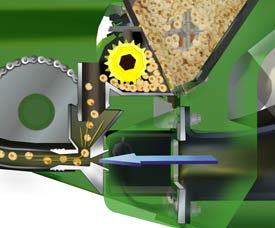 Seed meter and venturi
Seed meter and venturi
Metering of the seed is done at the tanks. While metering in volume, the co-efficient of variation from opener to opener is just 2 percent at the feed wheel. The population rates are controlled by meter speed as opposed to varying the amount of meter flute exposure as on a box drill.
By using this method, population rates can be better controlled, resulting in lower amounts of population variance from meter to meter. That is better than any other volumetric metering system on the market today.
The 1990 Central Commodity System (CCS™) also features metering gates at each individual metering wheel. This allows the operator to set the seed gate based on the seed size and population rate, to allow for even greater control of the population rates. The meter gate can also be used to shut off seed flow to an individual seed meter if desired.
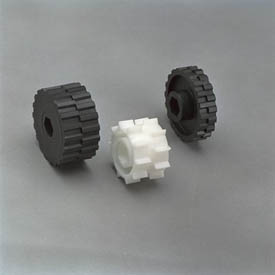 Meter rollers
Meter rollers
The 1990 CCS features three optional meter rollers:
-
The narrow black roller is recommended for low application rate crops such as sorghum.
-
The medium-rate black roller is used for application rates of up to 89.7 kg/ha (80 lb/acre).
-
The white high-rate roller is used for larger seeds and for high application rates. The white high-rate roller is also used for crops such as barley, oats and rice on 1990 CCS dual-rank models.
The metering rolls are interchangeable as well. Available metering bundles allow the operator to change over the complete meter assembly when changing crops from a high-rate crop to a lower population rate crop.
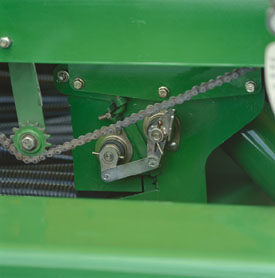 Oscillating agitation
Oscillating agitation
The 1990 CCS features an oscillating seed agitation system. The oscillating-style agitation system is more aggressive than a rotating style to be able to handle crops prone to bridging such as barley and rice.

Meters are color coded for quick reference:
Meter rollers |
|
| Black narrow | Low rates and small seeds (sorghum/milo only) |
| Black medium | Medium rates to 80 lb/acre; medium and small size seeds (milo and wheat only) |
| White | High rates of wheat, barley, oats, rice, and large seeds (soybeans) |
They can be easily removed or interchanged when changing over from seeding one crop to another.
Meter rolls are available from 18 port to 34 ports or nine rolls to 17 rolls per meter section.
Meter rollers are compatible with a wide variety of crops and rates.
IMPORTANT: 1990 CCS single-rank machines are compatible with soybeans, wheat, and milo. 1990 CCS dual-rank machines are compatible with soybeans, wheat, milo, barley, oats, and rice.
Electronic population rate control allows adjusting seeding rate on the go
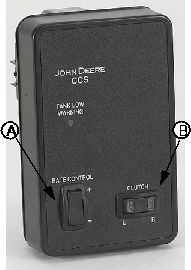 1990 Central Commodity System (CCS™) control box
1990 Central Commodity System (CCS™) control box
Seed populations can be changed on the go with electronic population rate control (EPRC).
A simple adjustment (switch A) in the cab allows either increasing or decreasing the seeding rates to match the target population. The EPRC allows operators to keep tight controls on population rates by allowing in-cab adjustments of population rates. The available seed-counting system allows viewing actual soybean population rates on the go.
Half-width disconnect (switch B) is in base equipment to allow seeding point rows or headlands without overlapping, saving seed and input costs.
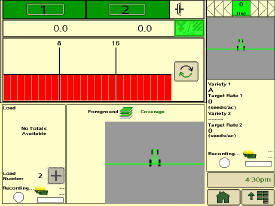 SeedStar™ 2 system with 1990 CCS in a run page
SeedStar™ 2 system with 1990 CCS in a run page
The half-width disconnects can also be activated and deactivated from within the SeedStar 2 main run page. The green boxes at the top of the screen with 1 and 2 in them indicate that both half widths of the drill are seeding.
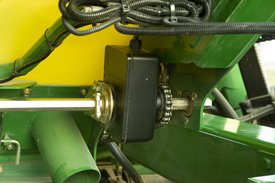 Half-width disconnect clutch
Half-width disconnect clutch
The electrically operated half-width disconnect clutch allows the operator to shut off half of the drive system conveniently from the tractor cab.
Air system gently delivers seed to openers
 Air system
Air system

1990 Central Commodity System (CCS™) air system features:
- Uses an air-delivery system to gently deliver the seed from the seed meters to the individual openers
- This air-delivery system provides accurate seed metering and increased productivity
- Also offers wide working widths in a compact transport package
NOTE: Tanks are not pressurized.
 CCS fan
CCS fan
 Plenum
Plenum
Airflow is generated by a 44.7-cm (17.6-in.) diameter, hydraulically powered fan.
The large-diameter fan and high-airflow:
- Gently move seed to the openers
- Minimize the chances of the air system plugging
- System requires up to 34.1 L/min (9 U.S. gpm) of hydraulic flow and a closed-center hydraulic system
- The fan is strategically located to minimize the chance of foreign material entering the air system
Air is then channeled to the plenums, which distribute the air evenly among all of the air runs.
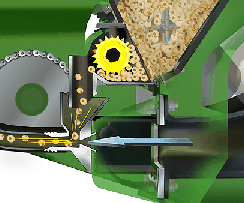 Venturi
Venturi

After the air has left the plenum, it enters the venturi area.
- The venturi generates an area where the seed is delivered into the airstream after it has fallen from the metering wheel
- The dual-rank 1990 CCS features:
- Larger-sized hoses
- Larger venturi throat openings
- Benefit: provide the system the capability of higher rates and additional crop choices
Seed blockage warning systems for Central Commodity System (CCS™)
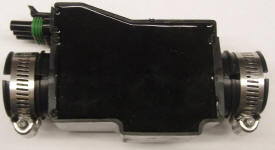 Blockage flow sensor
Blockage flow sensor
It is important to have the ability to monitor seed flow out of each individual opener.
The SeedStar™ 2 blockage system allows the operator to monitor product flow to each individual opener.
A product flow sensor is mounted on each 1-in. seed hose located after the flow splitter. The optical flow sensor uses infrared technology for seed flow detection to ensure that the sensor does not impede product flow through the seed hose.
SeedStar 2 blockage
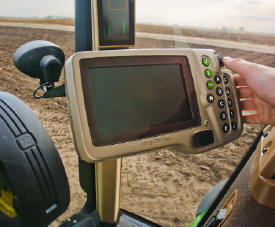 GreenStar™ display
GreenStar™ display
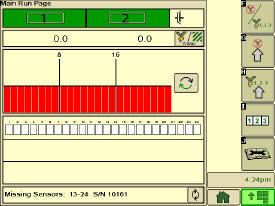 Blockage
Blockage
The SeedStar 2 display gives the operator an in-cab warning as to the exact row that has been blocked. The console will provide an audible alarm and display the exact row number to the operator that has become plugged. The SeedStar 2 display also has the ability to monitor seed population rates at the meters, reducing the number of in-cab consoles that are required by the producer.
SeedStar 2 works on both single- and dual-rank models. On dual-rank machines the sensor is located after the wye splitter. Single-rank machines have a sensor installed on each individual row.
Spoked gauge wheels
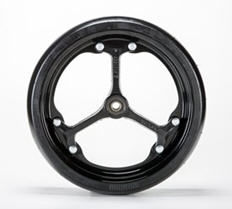
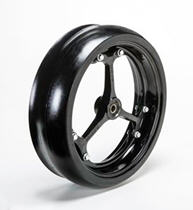
Growers have historically had to make some difficult planting and seeding decisions due to weather. Operators have been forced to plant in wet conditions that are far from optimal in order to plant within the optimum planting window. Those operators have experienced poor performance from wet soils working in between the depth gauge wheel and the opener disk and not having a way out. This creates the possibility of the depth gauge wheel or opener disk to seize up and drag through the soil.
The spoke gauge wheel is a solution for operators who plant in these conditions to allow the mud and debris that get caught behind the depth gauge wheel to easily flow through the wheel and continue providing superior depth performance.
The spoke gauge wheel is designed for optimum performance. Its features include serviceable, stamped inner and outer rims. The wheel also has cast spokes and bearing hubs for increased strength. This allows smaller spokes, creating larger open surface area for mud and debris to flow more easily than competitor’s wheels. Another improvement over the closed gauge wheel is a snap-ring bearing retention. Simply remove the snap ring, replace the bearing, and place the snap ring back.
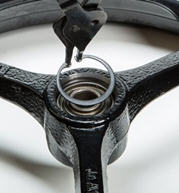 Gauge wheel
Gauge wheel
 Gauge wheel
Gauge wheel
Heavy trash fields from no-till environments have also tested very well with the new spoke gauge wheel. Some growers provided feedback of crop residue getting inside and jamming up the gauge wheel and opener. This spoke gauge wheel has shown exceptional performance within these areas as well. These wheels are compatible with both 90 Series openers on seeding tools and planter row-units.
Below is a chart that demonstrates a competitive advantage over MudSmith™ wheels for mud and residue flow:
| MudSmith | John Deere | Percent improvement | |
| Open area | 329 cm2 (51 cu in.) | 471 cm2 (73 cu in.) | 43 percent |
| Rim height | 1.9 cm (3/4 in.) | 1.4 cm (9/16 in.) | 25 percent |
| Spoke width | 3.5 cm (1-3/8 in.) | 1.9 cm (3/4 in.) | 45 percent |
The wheel is serviceable along with other parts.
- AA86055 – complete wheel assembly
- A101570 – inner wheel rim half
- A101571 – outer wheel rim half
Not compatible in dual gauge wheel applications.
MudSmith is a trademark of MudSmith, LLC.
ProSeries™ Openers provide excellent penetration
 ProSeries Openers
ProSeries Openers
ProSeries Openers are in base equipment on all 1890 and 1895 Separate Fertilizer Placement (SFP), 1990 Central Commodity System (CCS™), and 1590 Air Drills.
On the 1890 models, the single-disk openers are on 190-mm (7.5-in.) or 254-mm (10-in.) row spacing. On 15.25-m (50-ft) and 18.3-m (60-ft) 1890s, the 190-mm/380-mm (7.5-in./15-in.) or 254-mm/508-mm (10-in./20-in.) dual-row spacing feature is in base equipment. The single-disk openers provide consistent and accurate seed placement.
The ProSeries Openers are gang mounted and are hydraulically raised and lowered. The hydraulic downforce system also offers a wide range of downforce settings for the openers.
 Active hydraulic downforce pressure valve
Active hydraulic downforce pressure valve
The active hydraulics:
- Work in conjunction with the opener spring
- Provide an adjustable range of 75 kg (165 lb) to 180 kg (400 lb) of down pressure per opener
- Benefit: penetrate hard soils and heavy residue
- The cylinders allow the openers to travel up or down an additional 405 mm (16 in.) with active hydraulic down pressure to follow the ground
- Provide the openers additional pressure when needed or allow the openers to go into relief if the pressure becomes too high
The down pressure:
- Is easily adjusted with the pressure valve located on the front of the mainframe
- Provides the operator the ability to quickly adjust, or dial in, the down pressure as operating conditions change
NOTE: For additional ballast in hard-to-penetrate conditions, tractor suitcase weights may also be added to the mainframe and wings to obtain maximum down pressure per opener.
The Proseries Openers:
- Work not only in no-till conditions, but also in minimum or reduced-till conditions
- Provide 51 mm (2 in.) of free travel in the opener before spring down pressure takes over
- Benefit: allows the opener to move over uneven ground conditions and minimize the chance of the gauge wheels bulldozing soil in soft or mellow conditions
- The opener spring travels a maximum of 200-mm (8-in.) up or 150-mm (6-in.) down before the hydraulics react to uneven seedbeds
Features
SeedStar™ 4HP monitoring system
SeedStar 4HP is designed to optimize the in-cab monitoring experience exclusively on the Gen 4 4600 CommandCenter™ display or 4640 Universal Display for growers with ExactEmerge™ planters and MaxEmerge™ 5e planters model year 2018 and newer. With SeedStar 4HP, operators will easily see key planter information with customizable run pages, zoom functionality, and simultaneous graph and performance measurements. SeedStar 4HP is included in base on all model year 2018 ExactEmerge and MaxEmerge 5e planters.
Features overview:
- View multiple planters' at-a-glance bar charts simultaneously
- Three default planter run pages show key planter functions in easy-to-view layouts
- Highly configurable run pages allow SeedStar modules to be customizable
- Zoom feature allows quick row-by-row detailed information
- View dual bar graphs to see multiple planter details at one time
- SeedStar application to make adjustments to planter functions
- Simplified setup through the work set-up page
- Custom rates allow up to six different rates across 48 rows
- The SeedStar 4HP monitoring system requires the Gen 4 4600 CommandCenter or 4640 Universal Display. These displays allow the operator to benefit from the updated interface, enhanced processing speeds, and easy setup (learn more here).
SeedStar 3 HP conversion to SeedStar 4HP with mobile row-unit runoff aftermarket for field conversion kits
Growers who are currently running model year 2017 planters, model year 2017 and newer retrofit kits, or model year 2017 and newer custom-built planters with the SeedStar 3 HP monitoring system can upgrade to the SeedStar 4HP monitoring system with mobile row-unit runoff. The attachment part, AA100382, is software only. The Gen 4 display software version will need to be 19-1 or newer and will require planter apps. Follow the mobile runoff ordering and software push guide below for ordering and installation. Retrofitted planters and custom-built planters will also require the John Deere Connect Mobile kit, 0048PC, from the Precision Ag Technology Price Pages and wiring harness AA83662 to enable the mobile row-unit runoff feature. Please reference Parts Advisor and CCMS Solution 105181 for model-specific mounting brackets. SeedStar 4HP requires the Gen 4 4600 CommandCenter™ v2 display or 4640 Universal Display.
Default planter run pages
 Planter summary default run page
Planter summary default run page
 Planter overview default run page
Planter overview default run page
 Planter details default run page
Planter details default run page
Three default run pages show key planter functions in different views to give fast and easy access to important planter information.
Custom run pages
 Customizable run pages
Customizable run pages
There are customizable run pages that allow the operator to build pages that fit their operation with different modules, like the example shown above.
Zoom functionality
 Zoom feature showing a group of rows
Zoom feature showing a group of rows
 Zoom feature showing a single row
Zoom feature showing a single row
The zoom feature allows the operator to touch a section or row of the planter and get detailed information quickly.
Dual bar graphs
 Dual bar graph showing singulation and population simultaneously
Dual bar graph showing singulation and population simultaneously
Dual bar graphs allow operators to view multiple planter details at one time.
SeedStar application page
 SeedStar application run page
SeedStar application run page
In the SeedStar application, many adjustments can be made, including manually activating section control. SeedStar 4HP allows up to 48 individual row sections. There are several setup features such as crop, seed disk, number of rows being planted, population alarms, and limits. Seed rates can be modified, electric power generation (EPG) can be turned on or off, vacuum can be adjusted, and the fill and purge functions can be used from the SeedStar application. Frame control, as well as diagnostics and calibrations, can be accessed at the bottom of the screen.
Settings Manager in SeedStar 4HP
 Settings Manager screens
Settings Manager screens

Reduce set-up time between changing crops or field conditions by recalling saved settings used previously with Settings Manager, included with every SeedStar 4HP system. This feature allows saving and recalling planter and tractor settings for optimum performance in different conditions.
Settings Manager can be used to save all of the adjustment and inputs associated to a particular crop or condition. An example would be to store all population rates, downforce pressure, row cleaner adjustments, and closing wheel settings for planting corn and storing a separate, unique set of adjustments for soybeans. In addition, Settings Manager stores tractor settings such as selective control valve (SCV) flow and detents, infinitely variable transmission (IVT™) settings, eco modes, and more.
Custom rates in SeedStar 4HP
 Variety set-up page
Variety set-up page
 Rate set-up page
Rate set-up page
 Group rate set-up page
Group rate set-up page
Custom rates allow for individual row population control and row-by-row documentation where up to six different rates can be assigned across an up to 48-row planter. This allows growers interested in planting seed corn with ExactEmerge or MaxEmerge 5e the capability to assign specific populations to male and female rows for planting. This feature can also be used to create tram lines or other applications where custom rates by row are needed.
NOTE: Individual rates are tied to varieties, so each individual rate needs a unique variety name.
Compatibility
| SeedStar 4HP compatibility | |
| Planters | All models ordered with ExactEmerge or MaxEmerge 5e row-units NOTE: Retrofit kits are equipped with SeedStar 3HP only, but can be upgraded by purchasing part number AA100382. |
| Displays | Gen 4 4600 CommandCenter equipped with Version 2 Processor or 4640 Universal Display Dual-display mode is compatible with mid model year 2019 planter software. |
| Active Implement Guidance (AIG) | Compatible with SeedStar 4HP on Gen 4 displays with VT mode and required activations and subscriptions |
| AutoTrac™ Implement Guidance | Not compatible |
| AutoTrac Turn Automation | Not compatible |
Additional information
For additional information on feature functionality on the Gen 4 Display, visit the links below:
YouTube is a trademark of Google LLC.
Easy Fold

Easy Fold is a feature of SeedStar™ 4HP for MaxEmerge™ 5e row-units and ExactEmerge™ row-units equipped on 1775NT and 1795 Planters with a 2-point hitch or DB Planters. This integrated solution replaces the frame-folding box like the manual fold option in SeedStar 3 HP, and it has enhanced the process by controlling and automating the selective control valves (SCVs).
The one-operation fold reduces the need for training inexperienced operators by sequencing the process correctly and reduces time spent folding and unfolding. By utilizing implement automation, the hitch will be controlled by the planter during the fold cycle. Lining up the draft tube to the wing hooks is automated through this process, reducing operator tasks. On DB models, Easy Fold simplifies the folding process functions to one SCV. A manual process is available when needed.
A manual fold option is available from the frame control page on the display for non-compatible or non-equipped tractors or planters. The manual control function is accessible from each step of the Easy Fold process, as shown below.
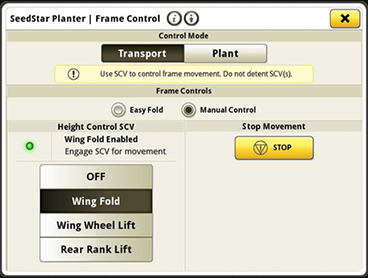 Manual control option on SeedStar 4HP
Manual control option on SeedStar 4HP
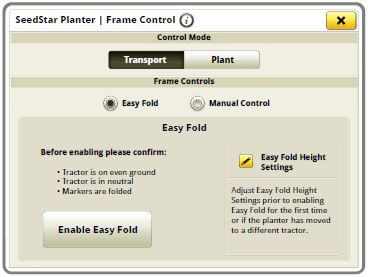 Start screen for Easy Fold
Start screen for Easy Fold
 Screen with Easy Fold enabled
Screen with Easy Fold enabled
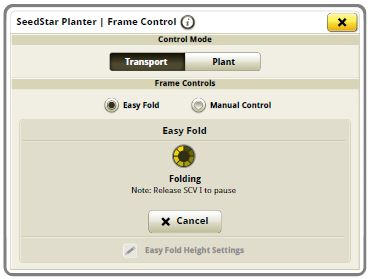 Screen with Easy Fold in process
Screen with Easy Fold in process
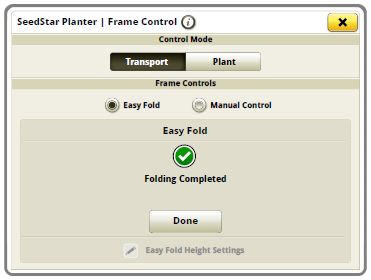 Easy Fold completed screen
Easy Fold completed screen
| Easy Fold compatibility | |
| Tractors |
|
| Activation | 2-point hitch equipped planters with Easy Fold require Tractor Implement Automation activation available from the StellarSupport™ portal. This activation is tractor PIN specific and non-transferable. Included in base on model year 2018 compatible tractors. See instructions below. |
| Planters | 1775NT and 1795 with 2-point hitch and DB Planters, equipped with ExactEmerge or MaxEmerge 5e row-units |
| Display | Gen 4 4600 CommandCenter™ Display or 4640 Universal Display |
NOTE: Included in base with ExactEmerge equipped compatible planters. Optional equipment on MaxEmerge 5e equipped compatible planters.
Tractor Implement Automation activation instructions
Use these instructions to download the Tractor Implement Automation activation code at no cost.
- Go to https://www.deere.com/en/stellarsupport/ or https://www.deere.ca/en/stellarsupport/
- Click Product Activation.
- Click Product Activation.
- Select Tractor Automation – Manage Product.
- Add or select existing tractor from list.
- Select the Activate button.
- Select Add Manufacturers drop down menu.
- Select Tractor Implement Automation – John Deere.
- Select Continue – Tractor Implement Automation – John Deere selected.
- Accept the Terms and Conditions.
- Select Finish.
- Take note of the code for use display.
- On the Gen 4 4600 CommandCenter Display or 4640 Universal Display select System, Software Manager.
- Select Activations, then Enter Code from John Deere Stellar Support.
- Enter activation code into the display in the tractor.
- Press next after activating Tractor Implement Automation.
- Take note of the activation code and press OK.
- The Tractor Implement Automation activation will appear the Software Manager screen.
NOTE: Prior to the 18.1 software release, the activation will be shown as “Unknown Implement 1” with a baler icon.
YouTube is a trademark of Google LLC.
Mobile row-unit runoff
 Row Runoff diagnostic test
Row Runoff diagnostic test
 The test functions from a mobile device
The test functions from a mobile device
 Determine optimum settings without being in the cab
Determine optimum settings without being in the cab
The first day of planting season can be as productive as the last with mobile row-unit runoff. The mobile row-unit runoff activation on the planter main controller (PMC) allows operators to make adjustments to maximize row-unit performance from a mobile device at the rear of the planter for both preseason and in-season use - all enabled through the PlanterPlus™ app.
Mobile row-unit runoff allows growers to perform test-stand functions from a mobile device connected to the planter.
The row runoff test provides complete diagnostic checks both preseason and in season. With the row-unit runoff test, the operator can make adjustments from the mobile device, including vacuum pressure, to determine the optimum meter and vacuum settings. This app functionality will help avoid making trips to the cab while validating meter performance.
During preseason planter inspections and set up, utilize the meter performance test to validate meter accuracy, similar to a test stand without leaving the farm. Test all systems on the planter, not just the meter, providing confidence that all planter systems are ready to plant. Reports are generated from the test providing information the operator can save and send for future reference.
Before heading to the field, the operator will benefit from knowing the best row-unit and vacuum settings for each variety selected to plant that spring.
Watch this video to see mobile row-unit runoff in action.
Mobile row-unit runoff will work with any model year 2015 or newer ExactEmerge™ or MaxEmerge™ 5e equipped planter. Mobile row-unit runoff can be added with attachment AA93169.
For model year 2018 and newer ExactEmerge planters, mobile row-unit runoff is included in base equipment. For model year 2018 and newer MaxEmerge 5e planters not equipped from the factory, mobile row-unit runoff can be added with attachment AA93169. A mobile row-unit runoff and Easy Fold package can be added with attachment AA97849 (only available with 1775NT and 1795 Planters with a 2-point hitch and model year 2019 and newer DB Planters with Gen 4 based frame folding).
NOTE: Mobile runoff utilizes PlanterPlus app available on select iPad® tablets, iPhone® smartphones, and Android™ devices.
Mobile row-unit runoff and Easy Fold aftermarket for field conversion kits
The below software bundles include the functionality explained above for machines not ordered with the feature from the factory. Compatible machines include all the necessary sensors and harnesses needed to make the feature function. The attachment part is software only. Follow the mobile runoff ordering and software push guide below for ordering and installation.
SeedStar™ 3 HP conversion to SeedStar 4HP with mobile row-unit runoff aftermarket for field conversion kits
Growers who are currently running model year 2017 planters, model year 2017 and newer performance upgrade kits, or model year 2017 and newer custom built-planters with the SeedStar 3 HP monitoring system can upgrade to the SeedStar 4HP monitoring system with mobile row-unit runoff. The attachment part, AA100382, is software only. The Gen 4 display software version will need to be 19-1 or newer and will require planter apps. Follow the mobile runoff ordering and software push guide below for ordering and installation. Performance upgraded planters and custom-built planters will also require the John Deere Connect Mobile kit, 0048PC, from the Precision Ag Technology Price Pages and wiring harness AA83662 to enable the mobile row-unit runoff feature. Please reference Parts Advisor and CCMS Solution 105181 for model-specific mounting brackets. SeedStar 4HP requires the Gen 4 4600 CommandCenter™ v2 display or 4640 Universal Display.
Mobile runoff ordering and software push guide
iPad and iPhone are trademarks of Apple Inc. Android is a trademark of Google LLC.
Downforce system options

Heavy-duty adjustable downforce springs
 Heavy-duty adjustable downforce spring
Heavy-duty adjustable downforce spring
Planter row-unit downforce is an important factor to ensure consistent and proper depth control. The heavy-duty adjustable downforce feature provides up to 181.4 kg (400 lb) of downforce. There are four settings available to allow the operator to choose the amount of downforce required for the condition: 0 kg (0 lb), 56.7 kg (125 lb), 113.4 kg (250 lb), and 181.4 kg (400 lb).
Compatibility: 1705, 1715, 1725, 1735, 1755, 1765, 1765NT, 1775 Flex, and 1785
Standard pneumatic downforce system
Pneumatic downforce provides convenient, simple adjustment of downforce for the whole planter from one location. The amount of downforce applied is infinitely adjustable from 0 to 181.4 kg (0 to 400 lb). Pneumatic downforce provides more consistent downforce throughout the range of row-unit travel than mechanical spring downforce systems.
Features include:
- 9.5-mm (3/8-in.) air delivery line instead of the 6.4-mm (1/4-in.) line used on model year 2010 and older planters.
- Air compressor assembly increased duty cycle. With this compressor, it provides a 47 percent increase in maximum air flow delivery compared to the prior air compressor.
- Pneumatic air bags with 9.5-mm (3/8-in.) air line inlets that have greater durability.
 Pneumatic downforce spring
Pneumatic downforce spring
Each row-unit has a single rubber air bag located between the parallel arms. The air bags are hooked in parallel so that air can be added or released from all rows at once from one location.
The individual pneumatic downforce air bag assemblies, air compressor units, and 9.5-mm (3/8-in.) delivery lines are also available as an attachment for field conversion.
 Pneumatic downforce compressor and gauge
Pneumatic downforce compressor and gauge
An improved compressor is used to charge the pneumatic system. This compressor can be located on the planter frame or in the tractor cab if desired. A gauge at the compressor indicates the amount of downforce being applied.
From the factory, integral planter models with pneumatic downforce will have an improved air compressor assembly with an in-cab mounting bracket, except for the 1725 16-row and 1725 Central Commodity System (CCS™) twin-row planters, which will have the air compressor assembly mounted on the planter frame. For drawn planter models, the 1755, 1765, 1765NT, 1775 Front-Fold, and 1785 Drawn Planters will have the air compressor assembly installed either on the outer hitch or wing frame members when the pneumatic downforce system is installed.
Base equipment on: 1705, 1715, 1725, 1735, 1755, 1765, 1765NT, 1775 and 1785.
Integrated pneumatic downforce system
The functional features of the integrated system are the same as the standard pneumatic system, explained above, with the addition of control through the GreenStar™ display.
System control with the GreenStar display
 Pneumatic downforce control in GreenStar 2 Display
Pneumatic downforce control in GreenStar 2 Display
 Air compressor mounted on 1775NT outer hitch
Air compressor mounted on 1775NT outer hitch
On 1725 16-row, 1725 CCS TR, 1775NT, 1775NT CCS, 1795, DR, and DB Series Planter models, the air compressor will be mounted on the outer hitch or frame assembly. Since the air compressor assembly is mounted on the outer hitch (as noted in the picture above) or frame, adjustments for row-unit downforce and related system pressures will be made electronically with the GreenStar display.
When adjusting the amount of row-unit downforce using the GreenStar display, the operator will select the amount of downforce (kg [lb]) to be applied across the planter. Depending on the soil conditions at hand, the operator might need to adjust the relative amount of row-unit downforce being applied during the planting operation. The integrated pneumatic downforce controls within the GreenStar display will only allow for set-point operation and not automatic control as the planter is operating in different soil conditions. The pneumatic downforce system does not have the capability to automatically adjust downforce.
On-board air storage
 Onboard air storage installed on 1775NT 24R30
Onboard air storage installed on 1775NT 24R30
The 1725 16-row, 1725 CCS TR, 1775NT, 1775NT CCS, 1795, DR, and DB Series planters will have onboard air storage to increase the overall response time when making a row-unit downforce adjustment from the GreenStar display. The onboard air storage is comprised of a 18.9-L (5-gal.) storage tank with valve assembly.
Base equipment on: 1725 CCS, 1725 16-row, 1725T, 1775NT, 1775NT CCS, 1795, DR, and DB Series Planters with MaxEmerge™ 5 row-units. MaxEmerge 5e and ExactEmerge™ equipped planters come with active pneumatic downforce in base.
Active pneumatic downforce
 Active downforce compressor assembly
Active downforce compressor assembly
 Hydraulic motor
Hydraulic motor
A hydraulically driven compressor works with the SeedStar™ 3 HP system and SeedStar XP system to automate downforce control. Just set the row-unit target margin value and the active pneumatic downforce system works automatically. The system will make sure the planter maintains this value, achieving precise soil penetration, and consistent planting depth, without sidewall soil compaction. From the factory, the system is set at 45.4 kg (100 lb) target downforce margin, but may be modified for varying field conditions. This frees the operator from constantly making manual downforce adjustments as conditions change.
This system offers a split-rank control feature for 1795 and DB Split-Row Planters. On split-row planters, active downforce will control the front and rear rows independently. This compensates for differing downforce requirements between the ranks that can be caused by things like different tillage or insecticide attachments and will help maintain an accurate planting depth and consistent margin across all the rows.
Active pneumatic downforce is available as factory installed or as an attachment for field conversion.
SeedStar XP row-unit downforce planter run page
 SeedStar XP downforce planter run page
SeedStar XP downforce planter run page
Active downforce control is integrated into SeedStar XP and SeedStar 3 HP monitoring systems.
Margin is the amount of weight riding on the depth gauge wheels that ensures desired firming of the seedbed as set by the operator.
Once a target margin has been defined, enter the value into SeedStar XP or SeedStar 3 HP and let active downforce do the rest. The system will actively adjust the air pressure in the air bags to maintain a constant margin across the planter. The changes in air pressure will change the amount of downforce placed on the row-unit, compensating and reacting for varying conditions through the field whether it is different tillage practices, soil types, or moisture.
 Downforce and margin example
Downforce and margin example
- A - Margin – amount of additional downforce applied to a row-unit above and beyond what is required for penetration to achieve planting depth. This additional weight will ride on the depth gauge wheels. 54.4 kg (120 lb) + 36.3 kg (80 lb) = 90.7 kg (200 lb) – 68 kg (150 lb) = 22.7 kg (50 lb) of margin
- B - Weight of row-unit - 54.4 kg (120 lb)
- C - Downforce – force that is applied to the row-unit by the air bag circuit - 36.3 kg (80 lb)
- D - Resistance from soil - 68 kg (150 lb)
Hydraulically driven compressor
 Hydraulic motor
Hydraulic motor
 Pneumatic valve
Pneumatic valve
The hydraulically driven air compressor can deliver up to eight times the air flow, allowing for more and faster downforce changes to be made. This more robust design features a 37.8-L (10-gal.) storage tank across all models with active downforce.
At approximately 15.1 L/min (4 gpm), hydraulic demands are low and ties into the machine’s lift and CCS hydraulic circuit so it does not require any additional selective control valves (SCVs). The SeedStar XP and SeedStar 3 HP monitoring systems work with the compressor and valve assembly to regulate air to downforce springs, enabling the active control.
Another feature of John Deere active downforce is the ability for the pneumatic valve to independently control split-rank machines. This system senses the downforce needs from the front and rear ranks separately and independently adjusts air pressures with the dual-rank pneumatic valve when equipped. Active pneumatic downforce requires SeedStar XP or SeedStar 3 HP to enable active control.
Base equipment on: All MaxEmerge 5e and ExactEmerge equipped planter models.
Individual Row Hydraulic Downforce (IRHD)

IRHD has been specifically designed to meet the needs of producers that are looking to adjust to the toughest field conditions and provide maximum yield potential from field to field, season after season. IRHD works as a closed-loop downforce system that reacts quickly on an individual row basis to changing soil conditions supporting increased ground contact, which can lead to improved seed depth consistency. When setting planter downforce margin, the system will apply the needed downforce by row to maintain ground contact. From the factory, the margin will be set at 45.4 kg (100 lb), changes may be required based on varying field conditions.
The system allows operators to maintain gauge wheel ground contact leading to desired seed depth placement. IRHD can adjust five times per second and make adjustments of 45.4 kg (100 lb) in less than a second. The system has a total range of applied downforce from 22.7 kg (50 lb) to 204.1 kg (450 lb) and utilizes the power beyond circuit on the tractor. IRHD is 58 percent faster than the active pneumatic downforce solution. Fast reaction and increased ground contact can lead to improved emergence. With uniform emergence, some studies have shown a yield impact from 5 percent to 9 percent.
IRHD is controlled through the Gen 4 4600 CommandCenter™ Display or 4640 Universal Display with SeedStar 4HP. As shown below, operators can view ground contact or applied downforce using the toggle button.
 IRHD screen showing the ground contact graph
IRHD screen showing the ground contact graph
 IRHD screen showing the applied downforce graph
IRHD screen showing the applied downforce graph
Optional equipment on: 1775NT, 1795, DB, and Orthman custom models with MaxEmerge 5e and ExactEmerge row-units.
Easy Adjust row cleaners
 Coulter combo row cleaner
Coulter combo row cleaner
 Easy Adjust row cleaner
Easy Adjust row cleaner
Easy Adjust row cleaner and coulter combo provides a pneumatic row tillage solution that is controlled from the seat of the tractor.
Every decision to make an adjustment during spring planting reduces the acres planted per day and can increase or decrease profitability. An adjustment that can be overlooked is row cleaners due to planter size, difficulty to make the adjustment, and varying conditions across fields and time.
 GreenStar™ 3 2630 Display view for row cleaners compatible with SeedStar™ 3 HP
GreenStar™ 3 2630 Display view for row cleaners compatible with SeedStar™ 3 HP
 4600 CommandCenter™ Display and 4640 Universal Display view for row cleaners compatible with SeedStar 4HP
4600 CommandCenter™ Display and 4640 Universal Display view for row cleaners compatible with SeedStar 4HP
With the Easy Adjust row cleaners on ExactEmerge™ planters, operators now have a pneumatic solution to make on-the-go adjustments that is controlled directly from the seat of the cab. They can be raised from the cab as needed with the push of a button for wet areas, waterways, or end rows. For growers using SeedStar 3 HP, the row cleaners are completely integrated into the John Deere GreenStar 3 2630 Display as well as the Gen 4 4600 CommandCenter display or 4640 Universal Display. For growers using SeedStar 4HP, a 4600 CommandCenter display or 4640 Universal Display is required.
The Easy Adjust row cleaners have the capability to save three presets for varying ground engagement based on field conditions. The system is controlled in three sections: at each wing as well as the center (frame or wheel) track rows. The pneumatic lines use air from the active pneumatic downforce compressor, requiring no additional compressor to be installed on the planter. The Easy Adjust row cleaners utilize down and up force air bags. The adjustable air pressure setting for each bag allows the operator to set the ride of the row cleaner depending on the field conditions and the desired results. Making these on-the-go adjustments from tractor cab increases productivity and performance during planting.
For Easy Adjust row cleaner performance upgrade kit options, see the ordering guide.
The row cleaner-only option utilizes parallel linkage to provide the floating action growers require in their fields. Parallel linkage allows for the unit to float up and down in the situation of hills or hard objects. The cleaner and coulter combo does not have parallel linkage, however, the row cleaners have floating rings installed to help provide the same benefits.
The row cleaners utilize the field-proven SharkTooth® design. Row cleaners play a major role in maximizing yield toward uniform emergence, reducing row-unit bounce, and maintaining proper depth. The Easy Adjust row cleaners provide growers with quick and stress-free solutions to customizing the planter in variable field conditions. They are available on ExactEmerge and MaxEmerge 5e equipped planters. They are not integrated into the RowCommand™ feature.
SharkTooth is a trademark of Yetter Manufacturing Incorporated.
Pneumatic closing wheels

Pneumatic closing wheels are compatible with MaxEmerge™ 5e and ExactEmerge™ row-units. They are available on the following models from the factory: 1775NT, 1795, and DB60 models. The pneumatic closing wheels give operators the ability to adjust closing wheels in seconds without leaving the cab of the tractor.
Using the GreenStar™ 3 2630 Display, pneumatic closing wheels can be adjusted to 25 different positions. From the factory the system is setup with two sections, the outer wings and center frame. With this system, producers will see up to a 76 percent increase in consistent force applied at the closing wheel. Consistently applying the correct force at the seed trench is one of the key elements of supporting improved emergence. Studies show potential yield impact on corn from even emergence from 5 percent to 9 percent*.
NOTE: Pneumatic closing wheels can be purchased for existing MaxEmerge 5e and ExactEmerge planters as an aftermarket field kit. Both rubber tire and cast-iron closing wheels are compatible.
Access the pneumatic closing wheels attachment for field conversion (AFC) ordering guide to fit a 1725 CCS, 1775NT, 1795, or DB60 Planter.
*Planting Outcome Effects on Corn Yield: Doerge, Tom, Jeschke, Mark and Carter, Paul
Curve compensation

Terraces or waterways are two of many field obstacles that make planting on a curve challenging. When planters utilize drive shafts, they are not able to control each individual row-unit; as a result, planting on a curve presents an issue of maintaining 100 percent population. Since the inside rows are moving slower than the outside rows, the inside rows will be over populating while the outside rows are under populating.
With ExactEmerge™ planters and equipped MaxEmerge™ 5e planters, the curve compensation feature allows each row to receive an individual signal based on the speed at which the row-unit is moving, maintaining the correct population across the width of the planter. Without curve compensation, there could be as much as a 24 percent drop in population accuracy, which is equivalent to 8,600 seeds per acre when planting at 36,000 seeds per acre. Curve compensation measures acceleration within the main planter controller and utilizes speed inputs to ensure each row has the desired population accuracy.
Row cleaner options to meet residue management needs
Crop yields have increased through the years along with the amount of residue left in the field after harvest. At the same time, tillage practices have changed, including different tillage operations which maintain large amounts of surface residue, and even no-till practices. Row cleaners are an essential tool in managing this increased amount of residue.
John Deere seeding group offers a variety of row cleaner options to meet the needs of a producer's operation. Compatibility varies by model, row spacing, and other planter equipment.
Screw-adjust, unit-mounted row cleaner
 Screw-adjust, unit-mounted row cleaner
Screw-adjust, unit-mounted row cleaner
The screw-adjust, unit-mounted row cleaner is mounted directly to the face plate of the row-unit, placing the ground engaging components just in front of the row-unit opener blades and depth gauge wheels. This close proximity allows the gauge wheels to control the depth of the row cleaner as well as the row-unit. This compact design also allows greater compatibility with fertilizer openers and other planter attachments.
SharkTooth® wheels are standard equipment on the unit-mounted row cleaner. The swept-tooth design of the wheel provides a clear path for the row-unit openers while resisting residue buildup on the wheel. The screw adjustment knob is accessible through the top of the parallel arms, providing convenient access for adjustments. The row cleaner can be adjusted in 1.6-mm (1/16-in.) increments, providing plenty of flexibility to meet the needs of changing conditions.
Floating row cleaner with unit-mounted coulter
 Floating row cleaner with unit-mounted coulter
Floating row cleaner with unit-mounted coulter
The floating row cleaner allows a row cleaner to be used in conjunction with a unit-mounted coulter. This combination is often desired in heavy residue loads and reduced tillage planting conditions. The row cleaner provides a clear path for the row-unit, while the unit-mounted coulter helps penetrate tough soil conditions.
Accommodating the unit-mounted coulter means the residue wheels are farther forward from the row-unit face plate than in the case of the screw-adjust row cleaner. To maintain performance, this row cleaner has the capability to float above a defined minimum depth.
Standard depth-gauging bands on the wheels allow the row cleaner wheels to float independently of the row-unit openers, allowing both to perform in varying terrain. The unit may also be set in a fixed position by simply pinning through the bracket if desired. This row cleaner also features SharkTooth wheels as standard equipment.
The floating row cleaner and unit-mounted coulters are available on many planters as factory-installed equipment. As compatibility and details vary by model, review the following links for information on specific planter models.
NOTE: Screw-adjust row cleaners are not compatible with MaxEmerge™ 5e row-units with long parallel arms.
NOTE: DB models have the option for either unit-mounted coulter, screw-adjust row cleaners, or pneumatic row cleaners (only compatabile with MaxEmerge 5e or equipped ExactEmerge™ models). The DB60T is only available with a less row cleaner option.
SharkTooth is a trademark of Yetter Manufacturing, Inc.
Drawbar hitch
 Drawbar hitch
Drawbar hitch

A factory-installed, optional drawbar hitch is available for use with 1775NT 16- and 24-Row, 1775NT Central Commodity System (CCS™) 16- and 24-Row, and 12.2-m (40-ft) 1795 Planters. For all DB models the drawbar hitch is in base. All DB models are available with Category 5 drawbar hitch. The following DB models are not available with Category 4 drawbar hitch: DB80 48R20, DB88 48R22, DB90 36R30, DB90 54R20, and DB120 48R30.
The planter drawbar hitch provides easy operation with plenty of ground clearance. The hitch design utilizes a hydraulic cylinder to raise the planter hitch for transport. Hydraulic oil for the hitch cylinder on 1775NT and 1795 Planters comes from the row marker system. Activation of this cylinder is accomplished using a single switch on the display and the marker selective control valve (SCV).
Due to the hydraulic system design, the drawbar hitch requires the planter be equipped with independent markers (not tied to planter lift circuit). Removal of markers from all planters, except the 1775NT 24Row30, makes the drawbar hitch inoperable. The 1775NT 24Row30 is the only planter where the drawbar hitch, less markers, is a valid combination.
For planting on 38.1-cm (15-in.) row spacing with a 16/32-Row 1795 Planter, the drawbar needs to be offset 19-cm (7.5-in.) on the tractor to center the planting rows behind the tractor. When the 16/32 1795 has a drawbar hitch, operators may not be able to offset the hitch to the exact specifications of 19-cm (7.5-in.) when planting in 38.1-cm (15-in.) operation, and could be off as much as a 1.3-cm (0.5-in.). To compensate, additional adjustments to the marker will be necessary.
When using a guidance system such as parallel tracking or AutoTrac™ assisted steering system, operators will need to use their implement offset when planting with all rows on 1795 Planters equipped with the drawbar hitch to compensate for the offset.
The drawbar hitch is ideal for those who have 9000 Series Tractors without a 3-point hitch. For these, the planter drawbar hitch is the economical choice instead of adding a 3-point hitch.
To accept the planter drawbar hitch, the tractor drawbar must be ordered with, or upgraded to, a Category 4 drawbar with the heavy-duty package or Category 5 to be compatible. Track tractors with wide-swinging drawbars are not compatible with the planter drawbar hitch due to a lower hitch-load capacity.
Each 1795 or 1775NT Planter ordered with the drawbar hitch will be shipped with a Category 4 hitch link installed. A Category 5 hitch link is also shipped with the planter if the planter is to be used with a Category 5 drawbar. See pre-delivery instructions included with the planter for changeover information.
Compatibility:
- Category 5 implement hitch links are not compatible with Category 4 tractor drawbars.
- Category 5 tractor drawbars are not compatible with Category 4 implement hitch links.
This hitch also adds 0.6-m (2-ft) to planter length during transport and field operation. There are some combinations of planter options that are not compatible with the drawbar hitch option due to tractor drawbar limitations.
DB fertilizer options
Option code 2625 – Liquid fertilizer with row-unit mounted in-furrow applicator:
- This option contains a ground driven pump, plumbing to a manifold, and routing to each row-unit. The in-furrow applicator places fertilizer after the seed and before the closing wheels.
The DB60 24Row Split 47 Planter and DB60 24Row Split 48 Planter applies fertilizer on 76.2-cm (30-in.) row spacing only.
Central Commodity System (CCS™) seed delivery system
 CCS
CCS

CCS seed delivery adds productivity through increased seed capacity, bulk fill capability, and easy, thorough cleanout.
The two tanks have a combined capacity of 2466.7 L (70 bu) on 9.1-m (30-ft) planters and 3523.9 L (100 bu) on 12.2-m (40-ft) and larger planters. CCS tanks are manufactured using a rotomolded, polyethylene design to ensure maximum durability. The translucent tanks allow easily viewing the amount of seed in the tanks. The tanks are separated by 54.6 cm (21.5 in.) for enhanced rear visibility during transport and backing.
The following crops can be planted with CCS: corn, sweet corn, popcorn, cotton, sunflowers, sugar beets, soybeans, and sorghum (milo).
Filling the tanks is convenient due to a central filling location. The staircase and railing provide access to the filling platform between the tanks. If filling the tanks with an auger, minimum recommendations are a 15.2-cm (6-in.) diameter, 4.3-m (14-ft) auger. Each tank has an adjustable bin-level sensor to alert the operator when it is time to fill.
A standard fill light package is available on machines equipped with CCS. This feature includes two lights conveniently mounted on the railings of the machine. The lights are turned on and off with their own switch located at the bottom of the staircase.
If the seed-carrying vehicle requires hydraulic power to run the unloading system, the auxiliary hydraulic coupler option is available. These couplers are located at the bottom of the staircase and can be coupled under pressure. The system has a separate system filter that ensures the planter hydraulic system remains free of contaminates.
Seed delivery process
CCS is about reducing the time spent filling the planter with seed while maximizing the time spent planting. CCS for planters is a form of seed handling and delivery. The row-units perform the final task of seed metering and placement.
The CCS seed delivery process relies on a hydraulically-driven fan to move seed from the CCS tanks to the row-units. This fan is plumbed in to the planter's raise/lower circuit, so only one selective control valve (SCV) is needed for both functions. When the planter is lowered, lift cylinders bottom out and hydraulic flow is diverted to the seed delivery fan. A flow control valve and gauge, located near the tank, allows for the proper tank pressure setting based on seed type.
Air from the fan pressurizes the CCS tanks and delivers seed to the seed hoppers. Airflow enters the seed tanks through a nozzle in the manifold which pressurizes the tank. The air then picks up seed and moves it out the other end of the nozzle into seed delivery hoses. These hoses route the seed toward the hopper. A small amount of seed is traveling in the delivery hoses only when needed.
The hopper fills with seed until the delivery hose (discharge elbow) is covered. Once the opening is restricted, seed flow through the hose stops. Air flowing to the row-unit travels into the hopper and is the source of air for the vacuum system. This provides a much cleaner air source than previous meter designs. As the seed is picked up by the meter and planted, the seed pool shrinks until the end of the delivery hose is uncovered. At that time, the airflow and seed delivery resume and the seed pool in the hopper is replenished.
CCS tank scales for DB Planter models
The CCS tank scales for DB models are a stand-alone system from Digi-Star®. Load cells are installed at the factory and can be ordered for CCS or CCS with Refuge Plus.
There are three load cells, two at the rear of the CCS cradle and one at the front. They weigh both tanks as one; individual tank weights cannot be determined.
The load cells and display are made by Digi-Star. They are not on the controller aread network (CAN) bus system so they are not integrated into SeedStar™ software in any way. The monitor is sold separately through Digi-Star.
CCS seed cleanout
Seed cleanout could not be much easier with a CCS planter. When finished planting, any remaining seed can simply be removed via access doors at the bottom of the CCS tank.
Because seed is only traveling through the CCS delivery hoses when required by the meter, there is not much left to clean.
CCS seed delivery hoses are then purged with air from the CCS fan, and the excess seed is pushed to the individual meters. The vacuum meter door is opened and seed is removed with the supplied catch pan.
Small seed CCS components
 Manifold nozzle and nozzle with cover installed
Manifold nozzle and nozzle with cover installed
 Straight seed inlet installed in mini-hopper
Straight seed inlet installed in mini-hopper
CCS seed delivery system increases planting productivity across the seven approved crops listed above. While highly effective delivering seed from the CCS tanks to the vacuum meters, small or light seeds (sorghum and small cotton) will require two additional components to aid in proper seed delivery.
Manifold nozzle covers (clips) should be installed to ensure seed is adequately picked up into the air stream for delivery to the row-unit. Mini-hopper discharge elbows should also be changed from the standard elbow (holes) to the small seed elbow (slotted openings) when planting sorghum (milo) and small cotton.
Digi-Star is a trademark of Digi-Star LLC.
Provide added versatility and productivity with Central Commodity System (CCS™) Refuge Plus planter configuration

DB44, DB60, DB60T, DB66, DB80, DB88, DB90, and DB120 Planters can be equipped with the Refuge Plus option from the factory.
The third tank on the Refuge Plus system provides increased versatility and productivity to the planting operation by allowing the grower to plant two different varieties simultaneously. The Refuge Plus tank has manifold nozzles, or outlets, to supply seed to eight different row-units.
Refuge Plus is ideal for the grower planting Bt corn or seed corn. Refuge Plus is the solution for refuge management compliance issues associated with Bt corn production. The 881-L (25-bu) capacity of the third tank makes planting the required 20 percent refuge of non-Bt corn easier while maintaining high productivity levels of the central-fill CCS.
For example, Bt corn planted on 80 percent of the field goes into the larger CCS tanks. The required 20 percent refuge, non-Bt corn, goes into the third Refuge Plus tank with the seed hoses routed to the desired rows.
Central fill with CCS is easier for the seed-corn grower as well. The seed-corn grower can plant both male and female seed in the desired pattern simply by placing the male seed in the Refuge Plus tank, the female seed in the CCS tanks, and routing the seed delivery hoses to the desired row units.
NOTE: Only DB44, DB60, DB60T, DB66, DB80, DB88, DB90, and DB120 Planters can be equipped with the Refuge Plus option from the factory. Other CCS equipped models can add Refuge Plus through Parts.
Redirecting seed delivery
 Seed delivery hose connection and yellow plug
Seed delivery hose connection and yellow plug
Redirecting seed delivery from the CCS tanks to the Refuge Plus tank is fast and easy with quick-disconnect couplers. By simply disconnecting the desired CCS delivery hoses from beneath the CCS tank, capping those hoses and reconnecting the delivery lines to the Refuge Plus tank, the seed delivery source is changed.
Due to the additional weight Refuge Plus places on the planter frame, liquid fertilizer tanks are not compatible. Updated liquid insecticide tank codes have been established for Refuge Plus planters.
Increase job performance when planting and spraying
 Connect Mobile comparison map lets users compare two quality layers at once for planting and spraying
Connect Mobile comparison map lets users compare two quality layers at once for planting and spraying
Connect Mobile overview
John Deere Connect Mobile is a solution that utilizes an Apple® iPad® tablet in the cab and helps the operator increase job performance during planting and spraying operations. Connect Mobile documents and displays multiple quality layers, helping the operator monitor and more easily detect problems that can occur during planting and spraying. Connect Mobile also has a common user interface that makes it easy to use between different pieces of John Deere equipment.
Planting attributes
Monitor and document key performance indicators in high-definition map layers and dashboard tiles such as:
- Actual population
- Target population
- Singulation
- Seed-spacing CV
- Applied downforce
- Gauge wheel margin
- Ride quality
- Ground speed
- Variety
Spraying attributes
- Actual rate
- Rate deviation
- Ground speed
- Pressure
In base equipment
Planting
Connect Mobile hardware is factory installed on all model year 2015 and newer planters factory installed with ExactEmerge™ row-units and all model year 2017 and newer planters factory installed with MaxEmerge™ 5e row-units, making it easy to get started with Connect Mobile.
Spraying
Connect Mobile hardware is factory installed on all model year 2018 Sprayers with the 4600 CommandCenter™ display. Producers can also retrofit Connect Mobile on older sprayers with a GreenStar™ 3 2630 Display by installing the sprayer field kit.
Learn more about Connect Mobile in the Field and Crop Solutions section within the Precision Ag Technology product line and how it can improve the quality of a planting and spraying job.
iPad and Apple are trademarks of Apple Inc.
Steerable axles
For increased maneuverability into narrow driveways and field approaches, the steerable axle is an option on all DB80, DB88, DB90, and DB120 models. The steerable transport axle still utilizes a pivoting rockshaft with dual lifting cylinders and combines a single steering cylinder with dual linkage assemblies. With the linked pivot points close to the centerline of each wheel, it allows a shorter cylinder stroke and smaller turn angles to translate into a tighter implement turn radius. The same 445/50R22.5 wheels are used with the steerable axle option.
The option will require an extra selective control valve (SCV), independent of all other implement functions. The option code will provide a full manually functioning axle assembly with an included in-cab display for calibrating and reading wheel angle position. The steerable axle package can be used for manual road transport functions around intersections and tight field entrances.
If desired, steerable axles can be combined with John Deere Active Implement Guidance (iSteer™ guidance and machine control system) to provide automatic planter guidance for in-field applications. The following additional components must be purchased separately from John Deere for the steerable axle to compliment Active Implement Guidance.
Components:
- iSteer tractor application controller (with activation)
- iSteer tractor harness
- StarFire™ receiver for planter
All required implement harnessing will be included in the option code. This includes the StarFire receiver harness. The receiver mast will also be provided when the option code is selected.
The purchase, installation, and calibration of the iSteer components are the responsibility of the dealership at time of predelivery.
Features
4600 CommandCenter™ display with SpreadStar™ system
 Run screen
Run screen
The F4365 is utilizing the 4600 CommandCenter display that is also found in large tractors today. The CommandARM™ controls, Generator 4 CommandCenter display and SpreadStar have been updated and tailored to the needs of operators allowing them to see all key functions on one run screen including AutoTrac™ assisted steering system, variable rate documentation, field totals, and dry spinner spreader settings. Click anywhere on the display to expand and easily adjust information.
 Work setup
Work setup
To prepare for field application, simply press the Setup button in the bottom left corner of the display run page, and it will direct the user to the Work Setup window.
- Select the Location box to setup user information including farm, field, and client. User information is not required to load and execute a variable-rate prescription.
- Select the Equipment box to do the initial setup of the machine including the number of bins in the dry spinner spreader.
- The Work Summary box shows a link for each bin in the dry spinner spreader. The screenshot above is for a two-bin dry box. Select each one to input or change the name of the product that will be applied. Twenty-four unique names can be entered into the display for various product types such as single product, blended product, or multi-product variable rate. The user can also choose the target rate for spreading or load a variable-rate prescription.
 SpreadStar
SpreadStar
Once the Work Setup Window is complete, the updated SpreadStar application can then be used to input and setup the following:
 Target spread rate
Target spread rate
 Bin details
Bin details
Target spread rate – selecting the target rate box allows the operator to quickly adjust three different target rates or load a prescription if needed. The target rates can be adjusted when spreading by using the corresponding buttons on the CommandARM.
Product density/product applied – selecting either of these areas will take the user to a bin details page where more frequent dry spinner spreader inputs and adjustments are made. For dry spinner spreaders with multiple bins, individual tabs at the top of the screen make it easy to quickly toggle between them.
Features on the bin details page include:
- Bin on/off
- Bin chaining (not shown)
- Product density
- CFR value
- Feed gate opening
- Bin alarms
- Resetting bin counter
- Belt prime
- Tarp control
- Chain oiler
Spinner Settings
 Spinner settings
Spinner settings
The last step is to setup the spinner settings by clicking on the spinner settings box in the SpreadStar application. The Add Spinner preset window will come up allowing the operator to create a new preset if they choose.
Preset functions include:
- Spinner target speed
- Spinner target speed alarms
- Spread width
- Fan frame setting
The bin details and spinner settings are saved with the Work Summary details. For example, an operator with a two-bin dry spreader may need to change between a two product variable-rate to a single blend application using bin chaining. When the operator switches back to two product variable rate, SpreadStar will automatically remember the bin details and spinner settings that were last used with that configuration.
Even with this feature, it is still important to calibrate the dry spinner spreader when changing products to ensure an accurate and consistent spread pattern.
Superior ride quality with dual c-channel chassis design
 Dual c-channel chassis
Dual c-channel chassis
The F4365 uses a dual c-channel frame design with leaf spring suspension to maximize ride quality and durability. The dual c-channel frame design is very strong, but it still allows the frame to flex. This is especially important when operating in rough field conditions at higher speeds because the frame will flex and absorb some of the impact loads instead of transferring it to the rest of the machine including the operator.
 Rear axle
Rear axle
Industry-proven AxleTech™ axles are used on the front and rear and are designed to haul full loads of heavier-density products such as lime.
 Front axle leaf spring
Front axle leaf spring
 Rear axle leaf spring
Rear axle leaf spring
Parabolic leaf springs are used on the front axle in conjunction with dampers and offer an industry-best 102 mm (4 in.) of travel. Parabolic leaf springs have fewer leaves, which reduce internal friction allowing for easier compression and articulation.
Dual-rate leaf springs are used on the rear axle to ensure consistent ride quality regardless of how much product is in the box. The first smaller set of leaf springs is used when the box is empty. When the box is loaded, the first set of leaf springs fully engages and combines with the second larger set of leaf springs. This design helps the F4365 drive and ride more consistently when applying in the field or in transport on the road.
The dual c-channel design, coupled with best-in-class suspension, helps absorb the impact loads and protects the operator and machine from harmful vibration. Reducing vibration improves productivity by reducing operator fatigue and decreasing the potential for failures caused by them.
Storage compartment
 External storage compartment
External storage compartment
An external storage compartment is located on the left-hand side of the machine and can be used to store important items nearby, but outside the cab:
- Personal protective equipment (PPE), such as gloves, goggles, face shield, apron, and emergency clothing
- Grease gun
- Density check tool
- Tools
Hydraulic folding ladder
 Hydraulic folding ladder
Hydraulic folding ladder
Operators will climb into the F4365 via a hydraulically controlled front ladder similar to 4 Series Sprayers. When the machine starts to move, the ladder will automatically fold up. When the machine stops, the operator simply hits the ladder button on the CommandARM™ control center to unfold it.
Cab and dry spinner spreader platforms
 Cab platform
Cab platform
 Spreader platform
Spreader platform
This industry-exclusive feature allows the operator to safely exit the cab and walk back to the dry spinner spreader to help with tendering or do a product density check.
Front retrieval points
 Front retrieval points
Front retrieval points
If the machine does get stuck while operating in wet conditions, retrieval points are located on the front of the frame to assist in pulling the machine out.
Fenders and mud flaps
 Front fender
Front fender
 Rear mud flaps
Rear mud flaps
Front and rear fenders protect the F4365 from mud and debris when operating in the field. Large front fenders similar to what are used on large row-crop tractors protect the front of the machine, even when turning. Rear mud flaps attached to the dry spinner spreader platforms on the right and left side provide excellent protection from debris thrown by the rear tires.
Optimal weight distribution
F4365 High-Capacity Nutrient Applicator and bin configuration |
Machine weight |
Front weight |
Rear weight |
Weight distribution (percent) |
|
Front |
Rear |
||||
Base machine with Single-Bin DN495 (empty) |
13,764 kg |
6,597 kg |
7,167 kg |
48 percent |
52 percent |
Base machine empty with Dual- Bin DN495 (MultApplier) |
14,444 kg |
6,623 kg |
7,821 kg |
46 percent |
54 percent |
Base machine empty with Four- Bin DN495 (MultiBin) |
14,556 kg |
6,407 kg |
8,149 kg |
44 percent |
56 percent |
Operator-friendly cab, controls, and display
CommandView™ III cab features and enhancements
 CommandView III cab panoramic view
CommandView III cab panoramic view
The F4365 High-Capacity Nutrient Applicator offers the same spacious CommandView III cab found in larger John Deere tractors and the 4 Series Self-Propelled Sprayers. This cab will keep operators comfortable all day long while providing great visibility and increasing productivity.
CommandARM™ controls
 CommandARM close up
CommandARM close up
The CommandARM has been updated and tailored for the specific needs of an operator. The AutoTrac™ assisted steering system resume and Master on/off buttons, along with the boom raise/lower switches are located conveniently on the multifunction handle, so the operator does not have to move their hand during application and headland turns. Additional controls for lighting, heating ventilation air conditioning (HVAC), radio, dry spinner spreader, and more are located conveniently close by.
CommandARM storage
 USB charging ports
USB charging ports
There are USB charging ports inside the storage compartment on the CommandARM armrest. These USB outlets are for charging only and do not connect to the radio or 4600 CommandCenter™ Display.
Generation 4 CommandCenter display
 4600 CommandCenter Display
4600 CommandCenter Display
The F4365 uses the Generation 4 CommandCenter display, similar to what is being used in larger tractors and sprayers today. SpreadStar™ system has also been updated to allow operators to see all key functions on one run screen including AutoTrac, John Deere Section Control, mapping, and application system settings. Importing and exporting user information and application data has been simplified and improved with Wireless Data Transfer, John Deere Operations Center, and AgLogic™ system.
Multifunction handle
 Multifunction handle
Multifunction handle
The multifunction handle gives operators convenient access to important nutrient applicator controls.
Operations that are controlled from the handle include:
- Raise/lower (fold/unfold) boom
- Center boom raise/lower
- Index boom section (IBS) control system
- Speed range
- Master system on/off
- AutoTrac resume
- Headland Management System (HMS)
- Emergency off
- Six reconfigurable buttons
Reconfigurable buttons
 Reconfigurable buttons on multifunction handle
Reconfigurable buttons on multifunction handle
 Speed range selector scroll wheel on multifunction handle
Speed range selector scroll wheel on multifunction handle
There are a total of nine reconfigurable buttons, six located on the multifunction handle and three on the CommandARM. Each button can be configured to one of the functions listed below:
- Master on
- Bin chaining
- Left tilt up/down
- Right tilt up/down
- Run page cycle forward
- Run page cycle back
- Swap track
- AutoTrac shift track center
- AutoTrac shift track left
- AutoTrac shift track right
- Close overlay
ComfortCommand™ seat
 Cab interior looking in from the door
Cab interior looking in from the door
The same great ComfortCommand seat in the 4 Series Sprayer is installed in the F4365 Nutrient Applicator. The seat provides superior ride quality with the ability to swivel 15 degrees to the right, improving operator comfort during application.
Additional cab features and options include a leather seat, Bluetooth® wireless system capability, a premium sound system, power mirrors, rear window tint, right-hand window wiper with fluid, and many more.
By keeping operators more comfortable during the day, the CommandView III cab will improve productivity while reducing the fatigue they experience throughout the day.
Bluetooth is a trademark of Bluetooth SIG Incorporated.
Improved machine performance equals more productivity
Engine and transmission
 9-L PowerTech™ engine
9-L PowerTech™ engine
 Infinitely Variable Transmission (IVT™)
Infinitely Variable Transmission (IVT™)
The F4365 uses an industry-proven 9-L PowerTech engine combined with an IVT to provide maximum power and efficiency.
The 9-L (549 cu in.) engine provides 272 kW (365 hp) rated horsepower and up to 298 kW (400 hp) peak horsepower when needed.
The IVT is common to the 8R Tractor Family, but has been modified for higher field and transport speeds.
Applicator field and transport speeds
 F4365 spreading in the field
F4365 spreading in the field
 F4365 in transport
F4365 in transport
The F4365 can apply product up to 48 km/h (30 mph) in field and travel on the highway empty at speeds up to 74 km/h (46 mph). The engine and transmission are common to other product lines in John Deere which means service locations, service intervals, and parts are all common.
 Fuel filling
Fuel filling
To ensure the F4365 can run all day long, it comes equipped with a 567-L (150 gal.) fuel tank and 29.5-L (7.8 gal.) diesel exhaust fluid (DEF) tank located on the right side of the machine. The slender tank designs are attached to the dual c-channel frame, reducing the torque load the tanks can have on the frame when full. Both tanks can be easily filled from ground level.
More versatility with the DN495 Dry Spinner Spreader
New Leader® Dry Spinner Spreader
The F4365 uses an industry-proven New Leader Dry Spinner Spreader. This 4.27-m (14-ft) long dry box is capable of holding 9.34 m3 (330 ft³) of product and is available in multiple configurations to meet a variety of application needs. Depending on the product, spread widths can range from 18.29 to 27.43 m (60 to 90 ft).
Single bin option
 Single bin option
Single bin option
The single bin option can be ordered in a 304 Stainless Steel or a 409 Painted Stainless Steel. A removable end gate, inverted V, and electric oiler come in base. At 24 km/h (15 mph), the single bin can spread fertilizer at rates as high as 499 kg (1100 lb) per acre or spread lime at rates as high as 2994 kg (6600 lb) per acre.
MultApplier insert
 Two-bin MultApplier insert
Two-bin MultApplier insert
A 2.1-m (7.0-ft) 304 Stainless-Steel MultApplier insert can be added to the single bin to spread two products at once. The MultApplier uses a belt over stainless-steel conveyor chain so no oil is necessary. Simply remove the end gate of the single bin to install the MultApplier insert.
MultiBin insert
 Four-bin MultiBin insert
Four-bin MultiBin insert
A 304 Stainless-Steel MultiBin insert can be added to the single bin to spread up to four products at once. In addition to the second large bin, two micronutrient bins are on the back of the MultiBin. Similar to the MultApplier insert, the MultiBin conveyor chain is belt over stainless-steel conveyor chain and does not require oil.
The divider separating the two micronutrient bins on the rear can also be removed to make one large micronutrient bin. Standard rate metering rollers come in base with the MultiBin insert. A pneumatically controlled lid covers the micronutrient bin(s) opening and is operated in the Generation 4 CommandCenter™ display.
New Leader is a trademark of Highway Equipment Company.
Improve application accuracy with the AB485 Air Boom


For ag service providers and large-scale producers, the AB485 Air Boom is available as an option for the F4365 High-Capacity Nutrient Applicator. The AB485 Air Boom builds on the advantages of the F4365 chassis with the addition of an 8.5-m3 (300-cu ft) dry box with dual-product capability and a 21.3-m (70-ft) wide boom.
Durability and uptime are extremely important to an ag retailer’s business. With the number of acres these machines need to cover each year and the varying weather conditions that can impact the schedule, increasing uptime is crucial to the profitability and success of the ag retailer. The AB485 Air Boom has been designed to maximize uptime through improved performance, reliability, and operator comfort.
Performance
 AB485 Air Boom
AB485 Air Boom
The air boom option allows operators to accurately apply dry fertilizer across a wide 21.3-m (70-ft) swath at speeds up to 48.3 km/h (30 mph), and at maximum rates up to 544.3 kg (1,200 lb) per acre at 16.1 km/h (10 mph). With its 8.5-m3 (300-cu ft) capacity dry box and dual-bin configuration, operators can simultaneously apply up to two products at variable rates to better meet crop nutrient needs with fewer passes over the field. Application accuracy is further improved with half-width section control.
 Air distribution system
Air distribution system
The air distribution system is an efficient design that consistently delivers even air flow from the fan to the booms. The closed-loop speed control allows the fan to run independent of the motor speed, making it more efficient as well. This design requires less power for the air system and puts more engine power to the ground during acceleration and operation.
Reliability
The electrical and hydraulic systems have been designed from the ground up with full integration into the 4600 CommandCenter™ Display for easier control and maintenance. The boom structure and supports have also been strengthened to extend the life of the booms regardless of the terrain.
 Fan oil cooler
Fan oil cooler
 Fan air intake with screen
Fan air intake with screen
To improve the reliability of the air distribution system, the fan oil cooler is mounted on the right side of the machine, exposing it to less dust and vibration while making it easier to maintain. A large screen was also added over the fan air intake to block residue and debris from entering the air system.
Operator comfort
 Hand rails on both sides of the dry box
Hand rails on both sides of the dry box
The front ladder provides easy access to the machine even when the booms are folded. During tendering, operators can quickly access the top of the dry box from the cab platform. Hand rails can then be folded up on both sides of the dry box, allowing the operator to work more efficiently.
The F4365 with the AB485 Air Boom improves the revenue potential for ag service providers by increasing machine productivity through greater durability and superior field performance.
Maximize seasonal capabilities with the LS475 Liquid System
 F4365 applying with the LS475 Liquid System
F4365 applying with the LS475 Liquid System
Seasonal flexibility is crucial for maximum machine utilization, and the seasonal capabilities of the F4365 are maximized with the LS475 Liquid System option. Together with Hagie™ Manufacturing, this liquid system is designed as a complete package with industry-leading advantages. Learn more on the LS475 product page.
Accurately apply low-rate herbicide and high-rate fertilizer with a single machine
 LS475 applying in the field
LS475 applying in the field
During the busy spring season, you need to complete jobs as crops are planted, from applying high-rate fertilizer on unplanted corn fields to low-rate pre-emergent herbicide on soybeans. Dual centrifugal solution pumps with dedicated magnetic flow meters work together to achieve pin-point rate accuracy through the entire flow range between 18.9 and 1589.9 L/min (5 and 420 gpm).
Fast, clean, automated tank filling enabled by PowrSpray™ technology
 LS475 load system keypad
LS475 load system keypad
When the tank is empty, every second counts trying to get back into the field. PowrSpray features independent fill and spray circuits with dedicated pumps to maximize flow. The dedicated self-priming transfer pump can fill the solution tank at over 1135.6 L/min (300 gpm). This PowrSpray system can:
- Automatically fill to a predefined tank level while automatically adjusting engine speed
- Pull fresh water from the rinse tank to clean the fill system
- Be manually reduced if a slower fill rate is desired
- Pause filling, giving you sufficient time to add ingredients and rinse containers
- Allow for quick and easy operation at the load station for all skill levels
Cover more acres per pass using the widest factory-installed boom
 LS745 boom
LS745 boom
The time-proven 27.4-m (90-ft) 4 Series Sprayer steel boom unlocks reliable productivity for ag service providers. This durable boom features:
- Full-boom breakaway
- Tri-direction boom-tip breakaway
- Auto-fold
The standard dual plumbing system features 76.2-cm (30-in.) off-center high-flow nozzle bodies (turrets) and a 152.4-icm (60-in.) on-center cam-lock. When configured for 152.4-cm (60-in.) cam-lock spacing, the effective spray pattern is 29 m (95 ft). The 76.2-cm (30-in.) nozzle body configuration achieves a 27.4-m (90-ft) spray pattern.
Cover more acres between refills with the large solution and rinse tanks
 LS475 solution and rinse tanks
LS475 solution and rinse tanks
With higher-speed planting, the season is becoming more condensed every year. When you need to get acres covered, getting tender trucks back to the plant increases productivity. To hold more product onboard, the LS475 solution system features a stainless steel 7570.8-L (2000-gal.) solution tank and black poly 757.1-L (200-gal.) rinse tank.
The large solution tank allows operators to cover more acres between refills. This tank gets tender trucks empty faster and back on the road, translating into less idle time for the tender truck and you and quicker load turn-arounds.
Hagie is a trademark of Hagie Manufacturing Company, LLC and similar to John Deere branded equipment, Deere will also support Hagie equipment.
Features
AutoTrac™ automatic guidance system
 5R Tractor with AutoTrac guidance system
5R Tractor with AutoTrac guidance system
John Deere guidance systems offer many benefits to the operator, including optimizing machine efficiency, reducing operator fatigue, and the ability to work at faster speeds.
AutoTrac is an assisted automated steering system that automatically steers the machine through the field.
AutoTrac
AutoTrac is an automated steering system that can be operated from 0.5 km/h to 30 km/h (0.3 mph to 18.6 mph).
- Straight track: operate in absolutely straight lines by defining a point A at one end and a point B at the other end of the field. Skipping lines for easy and fast turns at the headland is possible.
- Curve track: the curve track functions are available on all AutoTrac tractor models. In particular, when driving the first passes at the headland, the system follows the shape of the fields curves, driving curves with a constant or increasing radius and using AutoTrac at the headland after completing the first row.
- Markers: when a tank is empty, for example, the system marks this point in the field. After having filled up the tank, the display will guide the operator to the location they marked.
- Turning view: on the headland, the operator must manually steer the tractor close to the next pass and then press the resume switch. There is no need to place the tractor exactly on top of the beginning of the next row. This means saving time on the headland.
- Shift track: this function allows the operator to return to the field to finish work they started yesterday. Satellites move the whole time the operator is away and so the guidance line is not at the place from yesterday. The operator can press one of the shift track buttons to fix the line for the day’s work.
Benefits:
- Reduced implement overlap
- Greater field working speeds
- Reduced fuel and input costs
- Optimized machine efficiency
- Reduced operator fatigue
The tractor controllers process differential global positioning system signals from the StarFire™ receiver, the wheel angle sensor, and a steering wheel position sensor. It uses these signals to steer the tractor via the electrohydraulic steering valve. The steering wheel position sensor detects slight motion of the steering wheel. If the operator performs manual steering or leaves the seat, the system is shut off. To activate AutoTrac, simply press the Auto Resume switch to engage automatic steering.
 AutoTrac resume switch
AutoTrac resume switch
AutoTrac ready
The 5R Tractors can be equipped with an AutoTrac ready option from factory:
- GreenStar™/ISOBUS ready option
- Wheel angle sensor
- Electrohydraulic steering valve
- Steering wheel sensor
- Harnesses
AutoTrac Complete
AutoTrac Complete is a fully operational AutoTrac package ex-factory.
The 5R Tractors can be equipped with an AutoTrac Complete option from factory:
- AutoTrac ready (see AutroTrac ready section)
- Gen 4 4240 Universal Display
- StarFire 6000 Receiver
- Activation
 StarFire 6000 Receiver
StarFire 6000 Receiver
 4240 Universal Display
4240 Universal Display
NOTE: For more information on additional displays, receivers, and Precision Ag Technology products, refer to Precision Ag Technology product information.
NOTE: To use AutoTrac, a GreenStar display and StarFire receiver is required.
Industry-leading maneuverability
Utility tractor users often work in challenging environments, including in and around barns, fields, or livestock areas. Maneuverability is a priority as space can be limited at times. Implementing the single-piece mid-frame designs and the structural oil pan enabled the wheelbase of the 5R to shrink by 100 mm (4 in.) when compared to the Final Tier 4 (FT4) 5M Tractors.
 Single-piece mid frame
Single-piece mid frame
 Structural oil pan
Structural oil pan
The shortened 2250-mm (88.6-in.) wheelbase provides best-in-class turning with a 12.1 turning radius without the use of turning brakes. This calculation uses 13.6R24 front tires, which provide 58 degrees of turning angle and a full 10 degrees of axle oscillation.
CommandQuad™ Manual transmission provides fully electronic range and gear shifting
CommandQuad Manual transmission is base equipment on 5090R, 5100R, 5115R, and 5125R Tractors
The CommandQuad Manual transmission expands the proven reliability of the PowrReverser™ transmission with a 4-range, 4-speed transmission that enhances operator convenience and productivity through fully electronic manual range and gear shifting. The CommandQuad Manual uses the same final drives, rear axle, and differential as the already proven 5M PowrReverser transmissions. Rather than using mechanical synchronizers, the CommandQuad Manual utilizes powershift clutches. Also, electrohydraulic cylinders move the shift rails instead of a mechanical lever. This provides excellent ease of use and more efficient operation.
The CommandQuad Manual transmission is equipped with 16 forward and 16 reverse (16F/16R) speeds, a left-hand reverser, and four powershiftable gears in four fully synchronized ranges. The CommandQuad Manual transmission also comes with open centered hydraulics in base equipment, with the ability to option up to pressure and flow compensating (PFC) hydraulics from the factory. The base CommandQuad Manual transmission operates at speeds as slow as 1.9 kph (1.18 mph) with rolling circumference index (RCI) group 44 rear tires, and speeds up to 40 kph (25 mph).
For even slower speed options, a creeper is available as a factory-installed option (requires PFC hydraulics).
CommandQuad ground speed chart
CommandQuad with creeper ground speed chart
Operating the CommandQuad Manual transmission
 CommandQuad shift controls
CommandQuad shift controls
Range/gear controls
A single control lever, similar to the control used on the DirectDrive™ on 6R and CommandQuad™ on 7R, features an ergonomically designed and intuitive operator interface. This control lever provides manual gear and range change selection. This base transmission, although similar in operation to the optional Command8™ transmission, does not offer any automatic shifting capabilities.
Once the tractor is started, the operator selects a range by pressing one of the lettered range buttons on the right-hand console. The operator has five different selections to choose from - A, B, C, and two multi-range modes (BCD and CD). When a range with a single letter is selected, gear shifting is allowed within the specified range. When a range with multiple letters is selected, operators can shift between the designated ranges simply by using the toggle lever.
The gear within the range can be selected by using the transmission control toggle lever to electronically shift to a desired gear. After setting the desired throttle position, the operator can move the left-hand reverser to the forward or reverse position to start movement. The operator can shift up or down through the gears in the selected range(s) as needed.
The operator has the ability to shift through speeds and ranges without clutching by moving the toggle lever forward, toward the + indicator, or backward, toward the - indicator. A single movement of the toggle lever changes one gear at a time. Holding the toggle lever in either direction increases accelerates gear changes throughout the range at a faster pace.
When in a multi-range mode, a simple double toggle of the lever moves to the next range.
 Left-hand reverser
Left-hand reverser
Left-hand reverser
The electronic left-hand reverser is standard with all CommandQuad Manual transmissions and provides neutral-to-gear modulation, which allows a quick, convenient, and smooth forward-reverse shuttle shifting at any speed. The shifter must be lifted from either park or neutral position to forward or reverse to activate. The parking brake is also electronically controlled through the left-hand reverser.
The left-hand reverser is a great feature for loader tractors. The operator's left hand can control easily tractor direction while the right hand manages the loader joystick and speed changes.
Independent programmable forward/reverse ratio
This feature is helpful in cyclical operations, such as loader work, where the operator wants to control the forward speed as a ratio of the reverse speed.
In manual mode, the tractor automatically selects a gear closest to the ratio desired by the operator. In auto mode, the tractor would adjust the set speed in the opposite direction. Ratios can be programmed up to 100 percent faster than the forward speed or up to 80 percent slower than the forward speed within the cornerpost display. This is adjustable in 20 percent increments (forward speed x 0.20, 0.40, 0.60, 0.80, 1.00, 1.20, 1.40, 1.60, 1.80, 2.00).
Another selection is independent; in this mode the tractor remembers the last forward and reverse gear setting. Once the gear is manually changed in the reverse direction, the gear will automatically go back to the last gear when changing directions. If the gear is not manually changed when in reverse direction, then the forward gear and reverse gear will remain the same when changing directions.
While the maximum forward ground speed is 40 km/h (25 mph), the maximum reverse speed is 30 km/h (18.6 mph).
Standard advanced features of the CommandQuad Manual transmission
AutoClutch
With AutoClutch, which is standard on all 5R Utility Tractors, the operator no longer has to use the clutch to control braking and re-engagement of the tractor if so desired. The clutch pedal is still on the tractor for those operators that still prefer to manually foot clutch. This provides the ultimate in ease of use.
AutoClutch allows the operator to bring the tractor to a complete stop without clutching, while at the same time does not overload the engine. It also provides the ability to inch or creep the tractor forward or reverse on a level surface or incline. And it provides the ability to accelerate the vehicle back to normal speed when releasing the brake.
The operator can set the sensitivity setting of the AutoClutch system in the cornerpost display. There are three modes available:
- High sensitivity (default mode)
- Off – temporary setting only that is reset after a key cycle
- Low sensitivity
Low sensitivity would be typically used in transport applications with a towed implement. The low sensitivity ensures that the tractor and implement are stretched for better traction control.
Speed matching
When shifting ranges in a multi-range mode (BCD, CD), the transmission will shift to a gear that most closely matches the speed in the range from which the operator is shifting from, which improves operator comfort by making a smoother transition into a new range. There are two types of speed matching, passive and active.
With passive speed matching, when shifting to a new range, the tractor shifts to a selected fixed gear in the new range based on transmission ratios. For example, when shifting from C4 to D range, instead of shifting into D4 when the range is changed to D like a mechanically controlled transmission would do, the transmission shifts to a preset range and gear within range D. This most closely matches the transmission ratio from which the operator is coming from.
Active speed matching shifts up or down based on wheel speed during range shifts. This minimizes acceleration or deceleration when the clutch re-engages after a range shift and keeps a more consistent ground speed, improving operator comfort.
PowrReverser modulation
Similar to the 5M Utility Tractors, which offer a PowrReverser modulation dial to set aggressiveness of change in direction, all 5R Utility Tractors also offer PowrReverser modulation. Rather than a physical dial, the aggressiveness can be set through the cornerpost display. Settings can be set from 1 to 10, with 1 being the least aggressive direction change and 10 being the most aggressive direction change. A setting of 10 is popular for loader bucket applications where quicker directional changes are acceptable and more productivity is desired. Less aggressive modulation settings are ideal where smoother directional changes are required, such as bale stacking and pallet fork activities.
Start gear selection
Starting within gear 1 within every range has a negative impact on productivity. To minimize the amount of shifting required by the operator in many applications, start gears can be programmed by the operator when operating in any of the two multi-range modes.
In range CD, any start gear can be programmed into the cornerpost display between C1 and D1. In range BCD, any start gear can be programmed between B1 and D1. Let’s say that an operator programs B4 as the start gear for BCD range. Anytime the operator selects BCD mode by pressing that particular range button, the tractor will automatically begin in gear B4. The operator can of course shift to any range and gear between B1 and D4 from there, but the starting point will be what the operator has programmed. This results in less shifting and more productivity.
Within the fixed ranges (A, B, C), the preset start gears are A4, B4, and C4. These cannot be altered by the operator through the cornerpost display.
 Foot pedal lock switch
Foot pedal lock switch
Foot pedal lock
Similar to cruise control in a car, the foot pedal lock allows the operator to set a constant speed using the foot pedal. The switch to engage foot pedal lock is also located on the right-hand throttle control. To operate the feature, the hand throttle must be on the low throttle position. Use the foot throttle to increase the tractor to the desired travel speed, and then press the button to engage the foot pedal lock. When releasing the foot throttle, the tractor will then maintain the speed selected. It can be disengaged by either tapping the brakes, or moving the left hand reverser control to neutral or park.
Command8™ transmission for premium ground speed and load management
Command8 transmission is optional on 5R Tractors
The Command8 transmission expands the proven reliability of the PowrReverser™ transmission with a 4-range, 8-speed transmission that enhances operator convenience and productivity through fully electronic range and gear shifting, as well as automatic shifting capabilities. The Command8 uses the same final drives, rear axle, and differential as the already proven 5M PowrReverser transmissions. Rather than using mechanical synchronizers, the Command8 utilizes powershift clutches. Also, electrohydraulic cylinders move the shift rails instead of a mechanical lever. This provides excellent ease of use and more efficient operation.
The Command8 transmission is equipped with 32 forward and 16 reverse (32F/16R) speeds, a left-hand reverser, and eight powershiftable gears in four fully synchronized ranges. The Command8 transmission also comes with pressure and flow compensating (PFC) hydraulics in base equipment. The Command8 operates at speeds as slow as 1.9 km/h (1.18 mph) with rolling circumference index (RCI) group 44 rear tires, and speeds up to 40 km/h (25 mph).
Operating the Command8 transmission
 Command8 shift controls
Command8 shift controls
Range/gear controls
A single control lever, similar to the control used on the DirectDrive™ transmission on 6R and CommandQuad™ transmission on 7R, features an ergonomically designed and intuitive operator interface. This control lever provides manual gear and range change selection when in the left position, and auto selection when shifted to the right position. The thumbwheel is used to dial in the desired ground speed in the auto position.
Once the tractor is started, the operator selects a range by pressing one of the lettered range buttons on the right hand console. The operator has five different selections to choose from - A, B, C, and two multi-range modes (BCD and CD). When a range with a single letter is selected, gear shifting is allowed within the specified range. When a range with multiple letters is selected, operators can shift between the designated ranges simply by using the toggle lever.
The gear within the range can be selected by using the transmission control toggle lever to electronically shift to a desired gear. After setting the desired throttle position, the operator can move the left-hand reverser to the forward or reverse position to start movement. The operator can shift up or down through the gears in the selected range(s) as needed.
 Left-hand reverser
Left-hand reverser
Left-hand reverse
The electronic left-hand reverser is standard with all Command8 transmissions and provides neutral-to-gear modulation, which allows a quick, convenient, and smooth forward-reverse shuttle shifting at any speed. The shifter must be lifted from either park or neutral position to forward or reverse to activate. The parking brake is also electronically controlled through the left-hand reverser.
The left-hand reverser is a great feature for loader tractors. The operator's left hand can control easily tractor direction while the right hand manages the loader joystick and speed changes.
 Command8 in manual mode
Command8 in manual mode
Manual mode
The Command8 features two different ways to operate transmission range and speed selections. In manual mode, the operator has the ability to shift through speeds and ranges without clutching by moving the toggle lever forward, toward the + indicator, or backward, toward the - indicator. A single movement of the toggle lever changes one gear at a time. Holding the toggle lever in either direction increases accelerates gear changes throughout the range at a faster pace.
When in a multi-range mode, a simple double toggle of the lever moves to the next range.
 Command8 in auto mode
Command8 in auto mode
AUTO mode
Depending on load, auto mode will optimize both the engine and transmission by selecting the appropriate gear and rpm to optimize fuel efficiency. The only input needed from the operator is to set the target ground speed by using the thumbwheel. Once that target speed is set by the operator, the tractor takes care of maintaining that speed.
Once the operator has selected auto mode with the transmission shift lever, the following items will be displayed on the cornerpost display – auto activation, current ground speed, target ground speed, direction, range, and gear. If the operator has selected auto mode with the transmission control lever, then the operator can set the shift points of the transmission through the cornerpost display.
 Foot pedal lock switch
Foot pedal lock switch
Foot pedal lock
Similar to cruise control in a car, the foot pedal lock allows the operator to set a constant speed using the foot pedal. The switch to engage foot pedal lock is also located on the right-hand throttle control. To operate the feature, the hand throttle must be on the low throttle position. Use the foot control to increase the tractor to the desired travel speed, and then press the button to engage the foot pedal lock. When releasing the foot throttle, the tractor will then maintain the speed selected. It can be disengaged by either tapping the brakes, or moving the left hand reverser control to neutral or park.
Features available in both manual and AUTO mode
AutoClutch system
With AutoClutch, which is standard on all 5R Utility Tractors, the operator no longer has to use the clutch to control braking and re-engagement of the tractor if so desired. The clutch pedal is still on the tractor for those operators that still prefer to manually foot clutch. This provides the ultimate in ease of use.
AutoClutch allows the operator to bring the tractor to a complete stop without clutching, while at the same time does not overload the engine. It also provides the ability to inch or creep the tractor forward or reverse on a level surface or incline. And it provides the ability to accelerate the vehicle back to normal speed when releasing the brake.
The operator can set the sensitivity setting of the AutoClutch system in the cornerpost display. There are three modes available:
- High sensitivity (default mode)
- Off – temporary setting only that is reset after a key cycle
- Low sensitivity
Low sensitivity would be typically used in transport applications with a towed implement. The low sensitivity ensures that the tractor and implement are stretched for better traction control.
Speed matching
When shifting ranges in a multi-range mode (BCD, CD), the transmission will shift to a gear that most closely matches the speed in the range from which the operator is shifting from, which improves operator comfort by making a smoother transition into a new range. There are two types of speed matching, passive and active.
With passive speed matching, when shifting to a new range, the tractor shifts to a selected fixed gear in the new range based on transmission ratios. For example, when shifting from C8 to D range, instead of shifting into D8 when the range is changed to D like a mechanically controlled transmission would do, the transmission shifts to a preset range and gear of D2. This most closely matches the transmission ratio from which the operator is coming from.
Active speed matching shifts up or down based on wheel speed during range shifts. This minimizes acceleration or deceleration when the clutch re-engages after a range shift and keeps a more consistent ground speed, improving operator comfort.
 PowrReverser modulation settings in cornerpost display
PowrReverser modulation settings in cornerpost display
PowrReverser modulation
Similar to the 5M Utility Tractors, which offer a PowrReverser modulation dial to set aggressiveness of change in direction, all 5R Utility Tractors also offer PowrReverser modulation. Rather than a physical dial, the aggressiveness can be set through the cornerpost display. Settings can be set from 1 to 10, with 1 being the least aggressive direction change and 10 being the most aggressive direction change. A setting of 10 is popular for loader bucket applications where quicker directional changes are acceptable and more productivity is desired. Less aggressive modulation settings are ideal where smoother directional changes are required, such as bale stacking and pallet fork activities.
Start gear selection
Starting within gear 1 within every range has a negative impact on productivity. To minimize the amount of shifting required by the operator in many applications, start gears can be programmed by the operator when operating in any of the two multi-range modes.
In range CD, any start gear can be programmed into the cornerpost display between C1 and D1. In range BCD, any start gear can be programmed between B1 and D1. Let’s say that an operator programs B8 as the start gear for BCD range. This means that anytime the operator selects BCD mode by pressing that particular range button, the tractor will automatically begin in gear B8. The operator can of course shift to any range and gear between B1 and D8 from there, but the starting point will be what the operator has programmed. This results in less shifting and more productivity.
Within the fixed ranges (A, B, C), the preset start gears are A8, B8, and C4. These cannot be altered by the operator through the cornerpost display.
Independent programmable forward/reverse ratio
This feature is helpful in cyclical operations, such as loader work, where the operator wants to control the forward speed as a ratio of the reverse speed.
In manual mode, the tractor automatically selects a gear closest to the ratio desired by the operator. In auto mode, the tractor would adjust the set speed in the opposite direction. Ratios can be programmed up to 100 percent faster than the forward speed or up to 80 percent slower than the forward speed within the cornerpost display. This is adjustable in 20 percent increments (Forward speed x 0.20, 0.40, 0.60, 0.80, 1.00, 1.20, 1.40, 1.60, 1.80, 2.00).
Another selection is independent; in this mode the tractor remembers the last forward and reverse gear setting. Once the gear is manually changed in the reverse direction, the gear will automatically go back to the last gear when changing directions. If the gear is not manually changed when in reverse direction, then the forward gear and reverse gear will remain the same when changing directions.
While the maximum forward ground speed is 40 km/h (25 mph), the maximum reverse speed is 30 km/h (18.6 mph).
Load anticipation
A load anticipation feature is standard equipment on all tractors equipped with a Command8 transmission. Its primary function is to increase productivity and provide more operator comfort by assisting the operator to handle expected high-load situations by automatically increasing the fuel economy optimal engine speed when working with implements. It can be used in both PTO and hitch activities, and can be turned on or off for each within the cornerpost display.
If turned on through the display, load anticipation is activated when:
- PTO turned on – engine speed automatically increases to the maximum engine speed
- Hitch movement – engine speed automatically increases to 1500 rpm when a hitch movement is detected
The load anticipation feature also activates when using PTO or hitch functions programmed within iTEC™ system sequences.
Features available in auto mode only (Efficiency Manager™ feature)
Efficiency Manager is automatically enabled when the shift lever is placed in the automatic mode gate. The set speed adjuster on the top of the single lever gear selector allows the operator to dial in the desired ground speed to establish a set speed for forward and reverse. Efficiency Manager allows the transmission to up- or down-shift and change engine rpm to maintain the set wheel speed. To reach the desired set speed, the throttle must be set to full engine rpm. This allows Efficiency Manager to shift the transmission and adjust engine speed to maintain the desired wheel speed.
 Eco on / Eco off switch
Eco on / Eco off switch
Eco on / Eco off
In some applications an operator may want to manage parameters for shifting points and minimum engine rpm. This can be accomplished with settings within the cornerpost display via Eco mode. Eco mode can be turned off and on with a switch located on the hand throttle. In many cases, operators will choose to utilize Eco mode in lower load conditions, such as transport. For tough field conditions, Eco mode is typically turned off. Minimum engine speed is adjustable between 900 and 2100 rpm.
Eco mode allows the operator to program two minimum engine speeds, one for when Eco is turned off, and one for when Eco is turned on. When Eco mode is activated, the transmission and engine will shift up and throttle back in order to try to maintain ground speed at the low engine rpm selected by the operator. For example, if a grower chooses a target speed of 12 km/h at an engine speed of 1200 rpm. The transmission and engine will work together to shift to higher gears and throttle back to find a gear that is able to get close to the 1200 rpm target.
When the grower gets to the field and wants to increase engine rpm to handle working tasks, simply turn Eco off with the Eco button on the throttle control, and the transmission and engine will then shift down and throttle up. The tractor will again target the speed selected via the thumbwheel, and the engine rpm that has been programmed into the cornerpost display for Eco off.
This is an excellent way to maximize fuel efficiency on a 5R Utility Tractor.
![Load control droop (power take-off [PTO] on) settings in cornerpost display](https://salesmanual.deere.com/sales/salesmanual/images/NA/tractors/pic_to_come.jpg) Load control droop (power take-off [PTO] on) settings in cornerpost display
Load control droop (power take-off [PTO] on) settings in cornerpost display
Load control droop
Load control droop allows the operator to control the shift point of the tractor. The goal of auto mode is to prevent the engine pulling down below this preselected operating point by downshifting automatically. It commands an upshift so that the engine speed is above the load control set point (droop) with sufficient torque reserve. It also commands a downshift when the engine speed is pulled down below the load control set point (droop). The load control droop can be set within the cornerpost display in two modes, PTO on and PTO off.
The settings the operator can choose from in the cornerpost display are:
- PTO on
- High droop
- Medium droop
- Low droop
- PTO off
- High droop
- Medium droop
- Low droop
Selecting high droop minimizes shifting, while selecting low droop provides faster reaction to load.
Premium cab with high visibility panorama roof for the ultimate operating experience
The premium cab is designed to provide superior visibility for the ultimate operating experience, especially in front loader applications. This cab includes all of the features of the standard cab operator station plus much more. Some of the key features include:
- Panoramic sunroof with sliding top shade and pull down front sunshade
- Factory-installed radio
- Bluetooth® system ready
- Satellite capable
- Deluxe sound system with front-corner-mounted speakers and subwoofer
- USB port (for sound only)
- Auxiliary cord connection
- Additional interior cab light
- Rear windshield wiper
 Premium panorama cab
Premium panorama cab
Visibility
Featuring a single-piece front windshield, forward facing visibility has improved by 7 percent for easier loader attachment hookups and easier following of rows in vegetable and other row-crop applications. Upward visibility has improved 80 percent with the panorama roof in the premium cab, providing for easier bale stacking, pallet stacking, and dumping loads into walled trailers.
For improved ease of use and visibility in both sunny and adverse weather conditions, the premium cab comes standard with several tools to help get the job done. To shield the operator from the sun on bright days, an easy-to-use sliding overhead sunshade with an integrated front pull-down shade is provided. To provide additional visibility in adverse conditions, such as rain or fog, the premium cab comes standard with a factory-installed rear window wiper, and exhaust vents built into the back of the front-mounted speakers.
 Panoramic sunroof with sliding top shade and pull-down front sunshade
Panoramic sunroof with sliding top shade and pull-down front sunshade
Sound and radio
Standard factory-installed radio is Bluetooth ready and has satellite capability. The premium cab also offers a deluxe sounds system with front-corner- mounted speakers and a subwoofer behind the seat for enhanced sound performance. The satellite radio capability feature makes it easy for operators to connect the sound system to SiriusXM® radio. The premium cab comes with a Bosch® deluxe radio, and offers both an auxiliary and a USB port to connect custom electronic devices. Using the Bluetooth feature, customers are able to connect to their phones to the radio providing wireless connectivity. Integrated into this deluxe sound system is an additional interior cab light in the bottom of the left-corner-mounted speaker.
 Factory-installed radio
Factory-installed radio
 Bluetooth microphone
Bluetooth microphone
 Auxiliary cord connection
Auxiliary cord connection
Bluetooth is a trademark of Bluetooth SIG Incorporated. Bosch is a trademark of Robert Bosch GmbH. Sirius XM is a trademark of Sirius XM Radio Inc.
Loader joysticks with integrated transmission and direction control
Controlling speed and direction of the 5R Tractor in loader applications has never been easier. Whether the customer selects the CommandQuad™ Manual or Command8™ transmission, gear shifting and directional change is included as base equipment on any 5R Tractor that is equipped with mid selective control valves (SCVs). Both mechanical and electronic joystick options are mounted to the swivel seat. With a standard swivel seat, anytime the operator moves, the joystick also swivels along with it. This design improves operator comfort and operational efficiency by always having the loader controls at your fingertips.
 Mechanical loader joystick
Mechanical loader joystick
There are two types of loader joysticks available, mechanical and electrohydraulic. The mechanical loader joystick is mounted to the seat base, and is available with either open center or PFC hydraulics. The boom movement and implement rollback are controlled via cables from the loader joystick, which actuate the mid SCVs. If equipped with a third SCV for grapple functions, electronic buttons on the joystick control the opening and closing of the grapple.
On top of the loader joystick are buttons for gear selection. Pressing the rabbit or turtle buttons will shift the tractor by one gear. If the operator presses and holds the button, the tractor will more quickly accelerate through the gears when in a multi range selection (BCD or CD). Operating a loader tractor has never been easier.
The mechanical joystick can be easily locked out with a simple twist when the loader is not in use. Loader suspension can also be turned on and off on the face of the joystick with a switch.
 Electrohydraulic loader joystick
Electrohydraulic loader joystick
The electrohydraulic joystick is very similar to the mechanical joystick, but with a few key differences. This joystick also swivels with the seat, but is mounted at the end of the armrest rather than the seat base. Instead of cable control of the SCVs, it is fully electronic. The lockout is controlled electronically rather than with a mechanical lock. It is also available only with PFC hydraulics. The functionality is very similar to that of the mechanical joystick.
Either joystick option makes loader operation extremely comfortable on those long days of moving hay bales, stacking pallets, or general loader work.
**Electrohydraulic (EH) loader joystick is the only joystick compatible with CommandARM.
Loader joysticks with integrated reverser
Controlling direction on the 5R Tractor in loader applications has never been easier. Whether the customer selects the CommandQuad Manual or Command8 transmission, integrated joystick reverser is included as base equipment on any 5R Tractor that is equipped with mid selective control valves (SCVs).
 Reverser on mechanical loader joystick
Reverser on mechanical loader joystick
 Reverser on electrohydraulic loader joystick
Reverser on electrohydraulic loader joystick
The two types of loader joysticks available, mechanical and electrohydraulic, are both equipped with the reverser functionality.
On the side of the loader joystick is a button for reverser function. By pressing the button, the tractor will change direction.
This joystick reverser feature makes loader operation extremely comfortable on those long days of moving hay bales, stacking pallets, or general loader work.
Optional CommandARM™
Take command of the 5R Tractor with the optional CommandARM console. Bring the functionality of selective control valves (SCVs), power take-off (PTO) engagement, hitch adjustment, and loader controls to one common place while still having the functionality to swivel the seat. Integrating large tractor technology into the 5R Series, operators will notice common features such as easily identifiable SCVs with color coding as well as the PTO engagement switch.
 CommandARM console
CommandARM console
CommandARM provides individual access to the most frequently used controls.
- Engine throttle
- Transmission controls
- Electrohydraulic PTO
- Hitch/SCV controls (up to four rear SCV’s)
- Primary display unit (PDM)
- Loader joystick
Standard AutoClutch™ system for clutchless operation
 Brake pedals
Brake pedals
With AutoClutch, which is standard on all 5R Utility Tractors, the operator no longer has to use the clutch to control braking and re-engagement of the tractor if so desired. The clutch pedal is still on the tractor for those operators that still prefer to manually foot clutch. This provides the ultimate in ease of use, especially in applications where precise control and more stopping /starting is required.
AutoClutch allows the operator to bring the tractor to a complete stop without clutching, while at the same time does not overload the engine. It also provides the ability to inch or creep the tractor forward or reverse on a level surface or incline. Being able to inch or creep the tractor is an important tool for more efficient front and rear implement hookups. AutoClutch also provides the ability to accelerate the vehicle back to normal speed when releasing the brake.
 AutoClutch settings in cornerpost display
AutoClutch settings in cornerpost display
The operator can set the sensitivity setting of the AutoClutch system in the cornerpost display. There are three modes available:
- High sensitivity (default mode)
- Medium sensitivity
- Low sensitivity
- Off – temporary setting only that is reset after a key cycle
Low sensitivity would be typically used in transport applications with a towed implement. The low sensitivity ensures that the tractor and implement are stretched for better traction control.
Maximum fluid efficiency with Final Tier 4 (FT4) engines
The U.S. Environmental Protection Agency Agency (EPA) and Environment Canada requires all off-road diesel engines with 18.6 kW (25 hp) or more to meet stringent FT4 emissions regulations. John Deere uses the most efficient and cost-effective solution for the tractor package to meet emissions requirements at each horsepower level.
The engine powering the 5R is EPA certified Tier Level 4. This is achieved through a combination of a diesel oxidation catalyst (DOC) and selective catalytic reduction (SCR) using diesel exhaust fluid (DEF, or urea).
Several defining features on the 5R maximize the performance and reliability of the emissions package. A completely shielded DOC/SCR not only protects essential components from damage, it also keeps out dirt and debris. The well-packaged and tightly organized circulation system means there is more room to work around the tractor.
 PowerTech™ PWL Final Tier 4 technology
PowerTech™ PWL Final Tier 4 technology
Key components of the emissions system include:
DOC
John Deere has chosen to utilize an DOC to reduce NOx to create less particulate matter. By no longer including a diesel particulate filter (DPF) and increased efficiencies in other areas of the tractor, the result is improved total fluid economy (diesel and DEF) and a lower cost to the producer.
The engine is programmed to aggressively respond to changes in power needs, which can temporarily increase particulate matter. Since the DOC removes particulate matter instead of the engine, the engine is left free to do what it is designed to do – deliver all of the power, torque, plus transient response needed.
DEF
DEF is an ISO 22241 standard aqueous urea solution consisting of 32.5 percent urea and has a freezing point of -11°C (12°F). A 11.4-L (3-gal.) heated DEF tank used in conjunction with a 143.8-L (38-gal.) fuel tank keeps the operator in the field longer. A DEF tank heater is integrated with a temperature sensor, and plumbed engine coolant lines are used to promote thawing and prevent freezing in the tank during cold operation.
 DEF tank
DEF tank
The electronic control unit (ECU) controlled supply module draws DEF from the storage tank 11.4 L (3-gal.) and provides a pressurized flow to the dosing module. When the ignition key is off, the supply module pump will reverse direction to return any accumulated fluid back to the tank. The supply module is also fitted with a replaceable filter to prevent contaminants from entering the dosing lines. Both the supply module and dosing lines are electrically heated and controlled by the ECU to determine when DEF dosing can begin.
The dosing module is cooled by engine coolant and used to inject DEF at a pressure of 130 psi (900 kPa, 9 bar) into the decomposition tube. A harness is connected to the dosing valve that relays the needed DEF to inject based upon the amount of NOx exiting the DOC measured from the NOx tube sensor.
The decomposition tube is the internal mixing device used to circulate DEF with engine exhaust prior to entering the SCR/AOC after-treatment device.
SCR
To reduce the NOx, DEF is injected into the exhaust stream. When the exhaust gases combine with the DEF in the SCR catalyst, the NOx is broken down into nitrogen and water vapor.
 SCR location on the 5R Tractor
SCR location on the 5R Tractor
Benefits of air-to-air aftercooling
- Lowers the intake manifold air temperature
- Provides more efficient cooling while reducing temperatures for greater engine reliability
- Higher volume of air flows into the cylinders
- Engine is capable of meeting the increasing horsepower demands
Exhaust gas recirculation (EGR)
EGR reduces the high temperatures where these compounds are formed in the engine cylinders by replacing excess oxygen with a prescribed amount of cooled exhaust gas.
Exhaust gases contain more carbon dioxide than oxygen. The EGR valve, in conjunction with the venturi tube, and engine control unit (ECU), allow a controlled amount of exhaust gas to enter the intake manifold to mix with the incoming fresh air.
Replacing excess oxygen with cooled exhaust gas leads to:
- Lower combustion temperatures, creating less NOx.
In addition, EGR allows for:
- Advanced timing
- Optimal engine performance
- Maximum fuel economy
For added performance and efficiency, the engine passes the exhaust gases through an EGR cooler before it enters the engine.
Exhaust airflow enters into the EGR cooler from the exhaust manifold near the turbocharger. Based on engine load, air temperatures, and rpm, the ECU opens or closes the EGR valve, allowing a measured percentage of exhaust gas to enter the intake manifold. The gases mix with the rest of the incoming air from the turbocharger and aftercooler before entering the cylinders.
Turbocharged engine
The PowerTech PWL 4.5L utilizes one turbocharger — a fixed geometry, wastegate turbocharger. Fresh air is first drawn into the low-pressure fixed geometry, wastegate turbocharger, and compressed to a higher pressure. The compressed air is then routed to the charge air cooler and then to the intake manifold.
Combustion process with externally cooled EGR
Functions:
- According to engine operating conditions, the recirculated exhaust gases reduce the oxygen portion in the intake air to approximately 20 percent. Without any increase of the charge air pressure, the oxygen rate is not high enough to ensure a complete combustion of the fuel injected at high engine loads.
Advantages:
- Fuel-efficient combustion is achieved, because sufficient oxygen is provided.
A restrained, cooler combustion is realized, since the typical hot combustion process, which is generated by an oxygen surplus, is dampened by the inert exhaust gases. Hence, NOx emissions are reduced.
For more information regarding EPA regulations and the technology behind John Deere Integrated Emissions Control systems, please visit the following link:
http://www.deere.com/wps/dcom/en_US/campaigns/ag_turf/emissions/final_tier_4.page
Power bulge and torque reserve pull through the tough spots
Putting more power to the ground translates to increased productivity in demanding conditions. Simply put, torque is the useable power that can be achieved. More torque leads to more lugging ability which helps the operator be more productive.
5R Final Tier 4 (FT4) engines feature up to an 8 percent power bulge when put under load. The power bulge feature of the electronically controlled engine delivers additional horsepower as engine rpm drops below rated speed. Additionally, a 36 percent torque rise provides the force that maintains horsepower as engine rpm drops below rated speed.
When the tractor is under load, power bulge and torque rise work together to get through the tough spots and reduce the need to downshift. Horsepower and torque are mathematically related.
 |
As rpm drops, the only way to maintain or increase horsepower is to provide additional torque. The output horsepower is greater than or equal to rated horsepower as the engine is pulled down to 1750 rpm.
The peak torque rise also occurs near the rated economy power take-off (EPTO) speed for enhanced performance when operating in 540E power take-off (PTO).
NOTE: 5RH – 5115 hp only.
 5R torque curve summary
5R torque curve summary
 5R engine power curve summary
5R engine power curve summary
Intuitive digital cornerpost display
 Digital cornerpost display
Digital cornerpost display
The digital cornerpost display features state-of-the-art electronic instrumentation and blends well with the narrow right-hand cab post. This intuitive design eliminates the instrument cluster once surrounding the steering column while increasing forward facing visibility. In addition to displaying machine information, the cornerpost display also serves as the primary interface between the tractor and operator when adjusting hitch, transmission, hydraulic, and engine settings.
Information included in the display:
- Stop, service, and information alerts
- Exhaust filter cleaning indicator
- Engine rpm (engine speed)
- Fuel-level gauge with low-fuel warning
- Diesel exhaust fluid (DEF) level indicator
- Engine temperature gauge
- Power take-off (PTO) engaged indicator
- Range information (F, N, R, P), transmission range and gear indicator
- Gear and AUTO mode indication
- Ground speed
- Target speed (in AUTO mode)
- Field cruise
- Differential lock indicator
- Mechanical front-wheel drive (MFWD) indicator
- Turn signal and hazard indicators
- High-beam indicators
- Start aid time remaining (with electric air intake heater)
- Creeper indication (if equipped)
- iTEC™ system indication (if equipped)
 Cornerpost display interface
Cornerpost display interface
Interaction with the cornerpost display is primarily controlled with a button module mounted at the front of the right-hand upholstery. On the left side in green are a check mark button used to select items, a left arrow button that serves as a back button, and a menu button. The black wheel in the center is used for toggling within screens or adjusting settings.
To the right of the scroll wheel are hot buttons for frequently controlled settings, including draft control, hitch raise height, hitch drop rate, engine settings, transmission settings, and hydraulic settings. These buttons serve as shortcuts to make adjusting more common settings quicker and easier to access.
Cab suspension provides premium comfort
For operators wanting superior comfort and smoother driving, mechanical cab suspension is available for the 5R Series Tractors. The mechanical cab suspension reduces operator fatigue and improves comfort, especially when operating long hours in uneven fields. While offering a smoother ride, this factory-installed option also reduces noise and vibrations inside the cab from the engine, transmission, chassis, and implements one may be operating.
The cab rests on two rubber isolators at the front and two fully integrated shock absorbers at the rear which dampen the vibrations coming through the frame. The system provides stability to monitors in the cab helping to keep them in your viewing area.
 5R optional cab suspension
5R optional cab suspension
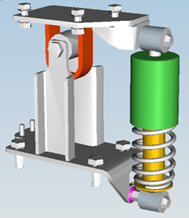 Mechanical cab suspension with mounting
Mechanical cab suspension with mounting
Features
PowerTech™ diesel engine provides low-end torque
The engine powering the 5075M is EPA certified Tier Level 4. This is achieved through a combination of a diesel oxidation catalyst (DOC) and a diesel particulate filter (DPF). John Deere uses the most efficient solution for the tractor package to meet emissions requirements at each horsepower level. The system always defaults to passive regeneration mode, and will only go into an active regeneration cycle when necessary without impacting engine performance. This active cycle takes place on average about every 40 hours of normal tractor operation. The regeneration process cleans out the DPF element.
Model |
Cylinders |
Engine displacement |
Engine hp |
PTO hp |
Rated rpm |
Aspiration |
5075M |
3 |
2.9 L (0.77 gal.) |
75 |
57.6 |
2400 |
Turbocharged |
As per 97/68/EC ISO at rated speed.
Other key engine features and related benefits:
- Heavy-duty cylinder block – strength and rigidity
- Balanced crankshaft – reduces engine vibration
- Optimized cylinder heads – improved airflow, better fuel economy
- Low friction, high-ring pistons – cast-aluminum design
- Plasma-coated top rings – reduced drag on cylinder wall
- Wet-type cylinder liners – dissipate heat to prevent cylinder wear
- Full-pressure lubrication system – eliminates excessive heat
- Electric fuel shutoff – does not allow bypass starting
Torque reserve for powering through tough spots
Torque
When the tractor is under load, power bulge and torque rise work together to get through the tough spots. Horsepower and torque are mathematically related.
 |
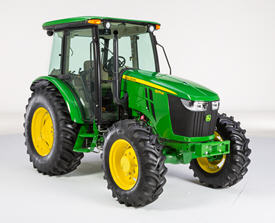 Power through tough spots
Power through tough spots
Benefits of torque reserve:
- Improved fuel efficiency
- Reduced noise levels
- Less downshifting
- Increased productivity
- Efficient throttle response
32F/16R PowrReverser™ transmission
For operators requiring more field speeds to achieve the most precise operating ranges, as well as for quickly moving from task to task with transport speeds of up to 40.23 km/h (25 mph), the 32F/16R PowrReverser Plus transmission is the ideal choice. This transmission provides 32 forward speeds and 16 reverse (32F/16R) speeds for the ultimate in speed selection. The transmission provides convenient push-button controls like the electrohydraulic high/low selector to gear up or down within a range without clutching.
For horticulture producers needing more precise ground speeds, a 32F/16R PowrReverser with creeper is available. This enables operators to move at a slower, consistent speed within a range.
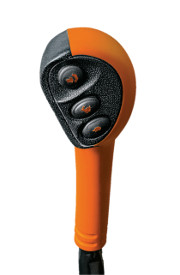 Gear-shift lever with incorporated declutch button
Gear-shift lever with incorporated declutch button
The rabbit/turtle feature benefits operators who frequently transport their tractors from field to field or find themselves in bog-down situations during rear power take-off (PTO) work. Operators can push the rabbit button (high) without having to depress the clutch to get a 20 percent increase in speed. They can also push the turtle button (low) to get a 20 percent decrease in speed, similar to downshifting or engine braking without having to grab another gear. The 32F/16R transmission includes the infinitely variable shuttle control feature. The PowrReverser has a built-in engagement override valve for additional safety. This valve requires the clutch pedal to be depressed one time after each engine start before the transmission will begin to operate normally, giving the operator another opportunity to put all focus on the tractor.
A neutral start switch requires the directional lever be in the neutral position to start the engine.
32F/16R transmission includes:
- Wet clutch
- Platform-mounted shift levers (four gears, four ranges, with hi/lo selector)
- Left-hand reverser (F to R without clutching)
- Constant-mesh, helical gears
- Pressure-lubricated top shaft
- Positive park paw
- Neutral start switch
- Speeds ranging from 1.75 km/h (1.09 mph) (A-1) to 36 km/h (22.4 mph) (D-4) with 480/70R28 tires on the mechanical front-wheel drive (MFWD) tractor
- For other ground speeds, please leverage the correction factors for other tires in the operator’s manual.
All tractors have economy power take-off (E-PTO), a fuel-saving feature that allows drivers to operate rear implements at 540 PTO rpm but at lower engine rpm. The result is lower engine vibration, reduced noise, less wear and tear on the engine, reduced fuel consumption and increased operator comfort.
See PTO functional area for more information on E-PTO.
Mid-frame design for support and strength
The exclusive mid-frame design on the 5M Series offers additional strength and durability but also reduces noise and vibrations. Because the mid frames are made from hardened cast steel, they will stand up to the toughest conditions and enhance loader operation stability and performance.
The mid frames also act as protection for different pieces of essential equipment. The hydraulic pump, located between the mid-frames, is attached to the transmission for short hydraulic lines and simplified fluid flows. An optional mid-mount fuel tank allows the tractor to carry an extra 30.3 L (8 gal.) of diesel. This is especially useful for long days in the field or when a trip to fill up may not be convenient.
The mid-frames are compatible with current loader mounting frames. This benefits customers interested in upgrading a tractor and keeping a H260 Loader.
Heavy base tractor weight for stability
A heavy tractor means more down force to keep implements in the ground. More weight also leads to improved traction and performance in the field. Because the 5M is made with heavy and durable cast steel, it weighs enough to power through those tough jobs.
The compactness of the 5M Series in regards to wheelbase, weight, and total height tractor makes this tractor suited for a variety of different applications and is the perfect choice for all types of farms.
A heavy tractor also means better stability when performing loader work. Transport full bucket loads faster and lift bales higher with a stronger and more stable base.
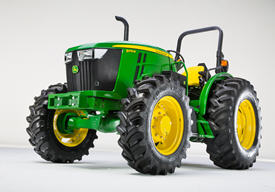 Tractor weight package
Tractor weight package
Model |
5075M* |
5090M |
5100M |
5115M |
| Two-wheel drive (2WD) open operator station (OOS) (lb; kg) |
7400; 3357 | 7300; 3310 | 7500; 3400 | N/A |
| 2WD cab (lb; kg) | 8300; 3765 | 8200; 3720 | 8400; 3810 | N/A |
| Mechanical front-wheel drive (MFWD) OOS (lb; kg) | 7900; 3583 | 7800; 3540 | 8000; 3630 | 8000; 3630 |
| MFWD cab (lb; kg) | 8800; 3992 | 8700; 3950 | 8900; 4040 | 8900; 4040 |
| With H260 mechanical self-leveling (MSL) OOS | ~8307 lb | ~8307 lb | ~8307 lb | ~8307 lb |
| With H260 MSL cab | ~9805 lb | ~9805 lb | ~9805 lb | ~9805 lb |
*FT4 5075M has diesel oxidation catalyst/diesel particulate filter (DOC/DPF)
Heavy-duty 3-point hitch lift capacity for implement versatility
The Category 2 3-point hitch on the 5M Series Tractors adapts to a wide variety of implements. Telescoping draft links with interchangeable hitch balls are factory-installed, enabling easier implement attachment. The 3-point hitch has plenty of lift capacity to handle heavy ground-engaging implements such as planters, sprayers, and field cultivators. The external cylinders allow a hitch lift capacity of 2174.1 kg (4793 lb) at 61 cm (24 in.) behind the hitch-lift balls.
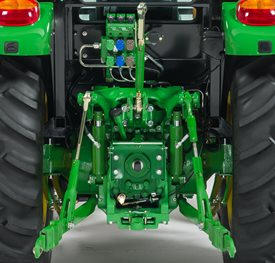 5075M 3-point hitch
5075M 3-point hitch

The 5075M comes standard with 56-m (183.7-ft) hitch lift cylinders, but the customer has the option of selecting the larger 63-mm (2.5-in.) lift cylinders that offer 2692.1 kg (5935 lb) of lift capacity at 61 cm (24 in.) behind the hitch lift balls from the factory (code 8458) or by ordering the field-installed heavy-duty hitch kit.
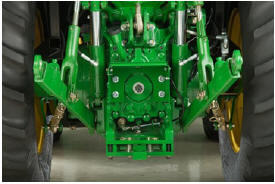 Heavy-duty 3-point hitch
Heavy-duty 3-point hitch

The sway bars can be easily adjusted to adapt to a wide variety of implements and the right lift link adjusts without tools for added convenience when leveling implements. Operators do not need to carry a tool to adjust the rear hitch.
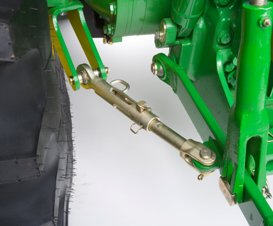 Adjustable sway bars
Adjustable sway bars
Features
Environmental Protection Agency (EPA) Final Tier 4 (FT4) compliant engines with maximum fluid efficiency
The U.S. EPA and Environment Canada requires all off-road diesel engines with 18.6 kW (25 hp) or more to meet stringent FT4 emissions regulations. John Deere uses the most efficient and cost effective solution for the tractor package to meet emissions requirements at each horsepower level. The 5M delivers a hassle-free emissions solution that allows faster work speeds and operation with ease.
The engine powering the 5E is EPA-certified Tier Level 4. This is achieved through a combination of a diesel oxidation catalyst (DOC) and a selective catalyst reduction (SCR) using diesel exhaust fluid (DEF, or urea).
Several defining features on the 5E maximize the performance and reliability of the emissions package. A completely shielded DOC/SCR not only protects essential components from damage but also keeps out dirt and debris. The well-packaged and tightly organized circulation system means there is more room to work around the tractor.
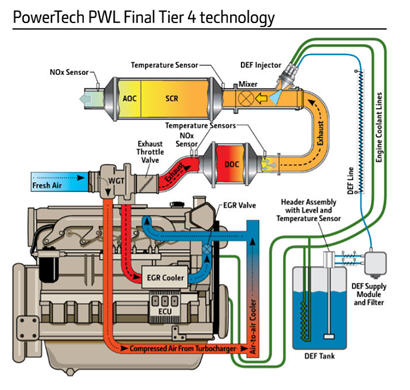 PowerTech™ PWL Final Tier 4 engine technology
PowerTech™ PWL Final Tier 4 engine technology
Key components of the emissions system include:
DOC
Deere has chosen to utilize an exhaust filter (DOC) to reduce particulate material so the engine can operate at a level which produces less nitrogen oxide (NOx). With less NOx created, it requires less DEF to treat. The result is improved total fluid economy (diesel and DEF).
The engine is programmed to aggressively respond to changes in power needs, which can temporarily increase particulate matter. Since the exhaust filter removes particulate matter instead of the engine, the engine is left free to do what it is designed to do – deliver all of the power, torque, plus transient response needed at the exact moment needed.
DEF
DEF is an ISO 22241 standard aqueous urea solution consisting of 32.5 percent urea and has a freezing point of -11° C (12° F). A DEF tank keeps the operator in the field longer even when the temperatures drop below freezing. The DEF tank header is integrated with a temperature sensor and plumbed engine coolant lines are used to promote thawing and prevent freezing in the tank during operation.
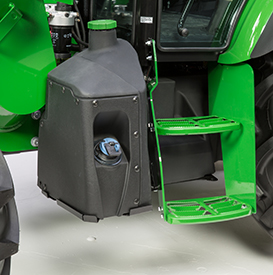 DEF tank
DEF tank
Mounted near the DEF tank, the engine control unit (ECU)-controlled supply module draws diesel exhaust fluid from the storage tank and provides a pressurized flow to the dosing module. When the ignition key is off, the supply module pump will reverse direction to return any accumulated fluid back to the tank. The supply module is also fitted with a replaceable filter to prevent contaminants from entering the dosing lines. Both the supply module and dosing lines are electrically heated and controlled by the ECU to determine when diesel exhaust fluid dosing can begin.
The dosing module is cooled by engine coolant and used to inject DEF at a pressure of 900 kPa (130 psi) into the decomposition tube. A harness is connected to the dosing valve that relays the needed DEF to inject based upon the amount of NOx exiting the DOC measured from the NOx tube sensor.
The decomposition tube is the internal mixing device used to circulate DEF with engine exhaust prior to entering the SCR/AOC after-treatment device.
SCR
To reduce the NOx, DEF, or urea, is injected into the exhaust stream. When the exhaust gases combine with the DEF in the SCR catalyst, the NOx is broken down into nitrogen and water vapor.
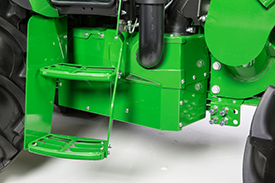 Shielded for protection
Shielded for protection
Exhaust gas recirculation (EGR)
How EGR works
EGR reduces the high temperatures where these compounds are formed in the engine cylinders by replacing excess oxygen with a prescribed amount of cooled exhaust gas.
Exhaust gases contain more carbon dioxide than oxygen. The EGR valve, in conjunction with the venturi tube, and ECU, allow a controlled amount of exhaust gas to enter the intake manifold to mix with the incoming fresh air.
Replacing excess oxygen with cooled exhaust gas leads to:
- Lower combustion temperatures, creating less NOx.
In addition, EGR allows for:
- Advanced timing
- Optimal engine performance
- Maximum fuel economy
For added performance and efficiency, the engine passes the exhaust gases through an EGR cooler before it enters the engine.
Exhaust airflow enters into the EGR cooler from the exhaust manifold near the turbocharger. Based on engine load, air temperatures, and rpm, the engine control unit (ECU) opens or closes the EGR valve, allowing a measured percentage of exhaust gas to enter the intake manifold. The gases mix with the rest of the incoming air from the turbocharger and aftercooler before entering the cylinders.
Series turbochargers
The PowerTech PWL 4.5L (274.6-cu in.) engine utilizes one turbocharger — a fixed geometry turbocharger. Fresh air is first drawn into the low-pressure fixed geometry turbocharger and compressed to a higher pressure. The compressed air is then routed to the charge air cooler and then to the intake manifold.
Benefits of air-to-air aftercooling:
- Lowers the intake manifold air temperature
- Provides more efficient cooling while reducing temperatures for greater engine reliability
- Higher volume of air flows into the cylinders
- Engine is capable of meeting the increasing horsepower demands
Combustion process with externally cooled EGR:
Functions:
- According to engine operating conditions, the recirculated exhaust gases reduce the oxygen portion in the intake air to approximately 20 percent. Without any increase of the charge air pressure, the oxygen rate is not high enough to ensure a complete combustion of the fuel injected at high engine loads.
Advantages:
- Fuel-efficient combustion is achieved, because sufficient oxygen is provided.
A restrained, cooler combustion is realized, since the typical hot combustion process, which is generated by an oxygen surplus, is dampened by the inert exhaust gases. NOx emissions are reduced.
For more information regarding EPA regulations and the technology behind John Deere Integrated Emissions Control systems please visit the following link:
https://www.deere.com/en/engines-and-drivetrain/final-tier-4-stage-iv/
or
www.deere.ca/en/engines-and-drivetrain/final-tier-4-stage-iv/
Torque reserve for powering through tough spots
 |
 4-cylinder 5E torque curve summary
4-cylinder 5E torque curve summary
24F/12R PowrReverser™ transmission for more speed selection variety
This PowrReverser transmission provides 24 forward speeds and 12 reverse (24F/12R) speeds. This transmission comes standard with a dual speed 540/540 Economy power take-off (PTO), and it is ideal for applications requiring frequent directional changes, such as loader work and PTO work like rotary cutting and baling hay.
Hydraulic wet forward and reverse clutches maximize durability and outlast the life of any dry clutch. When tractors are run by multiple operators with a variety of experience levels, a wet clutch is the best way to maintain transmission integrity and performance while decreasing clutch replacement costs.
Two platform-mounted levers offer easy and comfortable shifting. To distinguish the two levers for ease of operation, the gear-shift lever is longer and the less-used range lever is shorter. Unique knobs make it easy to distinguish between the two just by feel.
The hi/lo selector buttons are located on the gear shift lever for each forward gear, and are represented by a rabbit and a turtle respectively.
The forward lever selects one of four gears. All are synchronized for on-the-go shifting with the use of the clutch. The rear lever selects one of three ranges: A, B, or C.
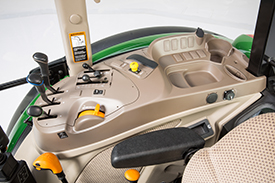 Gear shift lever with hi/lo buttons
Gear shift lever with hi/lo buttons
Maximum productivity is achieved with clutch-less hydraulic shifting between forward and reverse. PowrReverser functionality is ideal for rear blading and any applications that require frequent directional changes in tight spaces. An electrohydraulic fingertip directional lever control allows the operator to effortlessly switch directions with a small finger motion. The control is located on the left side of the instrument console and selects forward, reverse, and neutral positions. It also allows the operator to steer and shift direction with the left hand, freeing the right hand to operate other tractor controls, such as the loader, rear implements, or hand throttle. The PowrReverser has a built-in engagement override valve for additional safety. This valve requires the clutch pedal to be depressed one time after each engine start before the transmission will begin to operate normally, giving the operator another opportunity to put all focus on the tractor.
A neutral start switch requires the directional lever be in the neutral position to start the engine.
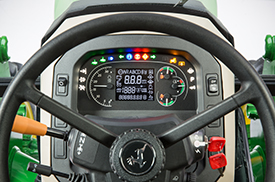 Left-hand reverser lever
Left-hand reverser lever
The speed of directional changes can be adjusted to the operator's preference or application demands with an optional field installed infinitely variable control kit.
24F/12R transmission includes:
- Wet clutch
- Platform-mounted shift levers with four gears (with hi/lo selector in forward) and three ranges
- Left-hand reverser
- Constant-mesh helical-cut gears
- Pressure-lubricated top shaft
- Positive park pawl
- Neutral start switch
All tractors have economy PTO (E-PTO), a fuel-saving feature which allows customers to operate rear implements at 540 PTO rpm but at lower engine rpm. The result is lower engine vibration, reduced noise, less wear and tear on the engine, reduced fuel consumption and increased operator comfort.
See the PTO functional area for more information on E-PTO.
Cooling package design and serviceability
Every utility tractor producer wants to maximize uptime and appreciates enhanced performance. The cooling package on the Final Tier 4 (FT4) 4-cylinder 5E Tractors allows for easier access to and serviceability of certain critical components. This improvement to serviceability will save time and also enhance tractor performance.
The cooling package features a first-pass screen to catch larger debris, a slide-out condenser (only on cab tractors) a charge air cooler that tilts forward, and a hydraulic oil cooler that slides out halfway to both sides of the tractor.
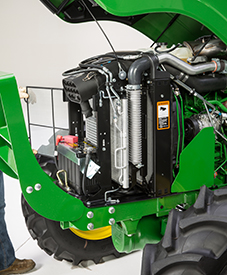 First pass screen
First pass screen
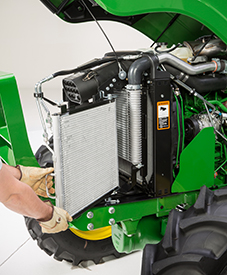 Slide out condenser on cabs
Slide out condenser on cabs
 Charge air cooler tilted forward
Charge air cooler tilted forward
The engine is equipped with an electronically controlled fan drive, which means that it only runs as fast as the needs of the tractor demand at that time. This is a fuel-saving device which improves hydraulic cooling and reduces the noise level for the operator. It also positively impacts total fluid efficiency.
540/1000 power take-off (PTO) rpm kit for implement versatility
Producer needs drive John Deere to deliver distinctive value in product solutions. The applications in which John Deere utility tractors, implements, and attachments are used are growing by the day. A 540/1000 PTO rpm field-installed kit is available for the 5E Tractors. With this kit installed, operators can switch between standard 540 or 1000 PTO rpm based on the requirements of the implement. From rotary cutting, to shredding to snow throwing and baling, the capability to operate an implement requiring 1000 rear PTO rpm is available.
Once installation is complete, this solution offers the convenience of switching between 540 and 1000 PTO rpm with relative ease. Combined with the dry sump design, this attachment includes a reversible shaft. This provides for a less mess, no stress option that will enhance customer productivity and increase uptime.
 540/1000 PTO rpm field-installed kit
540/1000 PTO rpm field-installed kit
Liquid-crystal display (LCD) instrument cluster
An instrument cluster provides more information in a cleaner, more vibrant display. The roll-mode function has the ability to show more diagnostic codes to keep the operator informed about the tractor’s functionality.
This window into tractor functionality and diagnostics provides ample information. Indicators, warning lights, and even gauges are clear and bright. The roll-mode function now provides operators with crucial onboard diagnostics. Engine hours, power take-off (PTO) speed, ground speed, hi-lo indicator, forward, neutral, and reverse are all visible at the same time. There is a light-out indicator for trailer light, turn light, and hazard light bulbs which is driven by updated software. It is a straightforward layout and sleek design with no customer interface required. When operating the PTO, there are clearly presented PTO target bars to indicate the correct PTO speed.
 Instrument cluster lights
Instrument cluster lights
There are daytime and nighttime modes which are based on the position of the light switch. The mode adjusts the backlight levels of the display for optimum visibility.
Features
Attractive styling provides improved visibility and serviceability
 3R Open-Operator Station Tractor
3R Open-Operator Station Tractor

The bold styling of the tractor provides an attractive and functional appearance similar to that of the larger agricultural tractors. Benefits of this styling include:
- Easy tractor family identification
- Updated fixed grill and side panel hood design allowing for optimum sealing of the cooling compartment
- Integrated maintenance position on front grill for easy battery access
- Wraparound-style halogen headlights
- Premium integrated automotive style headlight bezels
- Bold graphics allowing for easy tractor family identification
- Aggressively sloped hood design giving a softer, smoother look, and providing improved visibility
- Hybrid exhaust in base for clear operator visibility and safety
The result gives the tractor a distinctive appearance and feel.
NOTE: If tractor is equipped with optional field-installed vertical exhaust, exhaust pipe must be removed before opening and closing the hood of the tractor.
Powerful Yanmar® diesel engine delivers plenty of power under heavy loads
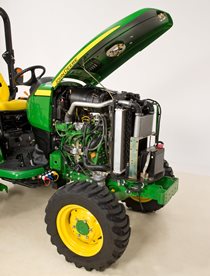 Yanmar 3-Cylinder, TNV Series diesel engine
Yanmar 3-Cylinder, TNV Series diesel engine
The Yanmar 3-cylinder, TNV series diesel engine features a high torque reserve that provides plenty of power under heavy loads.
This engine features lower levels of exhaust emissions and reduced noise levels. The engine meets all current Environmental Protection Agency (EPA) emission requirements for Final Tier 4 emission standards.
The 1.642-L displacement, naturally aspirated, 3TNV88C Yanmar diesel engine provides 31.8 hp to the 3033R Tractor.
Model |
Number of |
Engine |
Rated rpm |
Gross engine hp* |
Gross engine ps* |
PTO hp* |
3033R |
3 |
1.642L |
2600 |
31.8 |
32.2 |
23.6 |
*Engine hp (kW), gross SAE J1995: 32.2 (23.7) at 2600 rpm, PS
Displacement, in3 (L):100.2 (1.642)
3039R
The 1.496-L, turbocharged, 3TNV86CT CR Yanmar diesel engine provides 38.2 hp to the 3039R Tractor.
Model |
Number of |
Engine |
Rated rpm |
Gross engine hp* |
Gross engine ps* |
PTO hp* |
3039R |
3 |
1.496L |
2600 |
38.2 |
38.7 |
31.3 |
*Engine hp (kW), gross SAE J1995: 38.7 (28.5) at 2600 rpm, PS
Displacement, in3 (L): 95.7 (1.568)
3046R
The 1.496-L, turbocharged, intercooled 3TNV86CHT CR Yanmar diesel engine provides 44.7 hp to the 3046R Tractor.
Model |
Number of |
Engine |
Rated rpm |
Gross engine hp* |
Gross engine ps* |
PTO hp* |
3046R |
3 |
1.496L |
2600 |
44.7 |
45.3 |
34.1 |
*Engine hp (kW), gross SAE J1995: 45.3 (33.34) at 2600 rpm, PS
Displacement, in3 (L): 91.3 (1.496)
The engine uses latest technologies to optimize fuel economy, improve control and accuracy, and reduces environmental impact.
The common rail system (CRS) optimizes fuel economy and reduces operating costs*. High pressure injection atomizes fuel into finer particles which burn more completely. It results in improved fuel economy and lower cost of operation.
The electronic control unit (ECU) provides optimum fuel control and accuracy. ECU monitors and controls the engine. It continuously monitors engine conditions and adjusts the fuel delivery accordingly to ensure optimum performance and emissions.
The new engine comes with an after treatment system. The system operates automatically. The exhaust filter consists of a diesel particulate filter (DPF) which captures particulate matter (PM) contained in the exhaust gas. Using a natural cleaning process, most of the PM trapped in the exhaust filter is eliminated by the heat of the exhaust stream generated by normal use. In situations of low temperature, engine speed or load factor, an active cleaning cycle is initiated. In this cleaning cycle, the exhaust gas temperature is raised by injecting additional fuel during the exhaust stroke of normal vehicle operation to the diesel oxidation catalyst (DOC).
After many hours of use, the exhaust filter may require an ash removal service.
NOTE: *As compared to engines not using CRS technology.
DPF cleaning
Depending on the load that the tractor is under, as well as ambient temperature, humidity, and engine speed, the DPF may build up with particulate matter, thus requiring cleaning. Filter cleaning is determined by one of three conditions:
- A prescribed time-based estimation of needed filter cleaning
- DOC/DPF pressure sensors
- A particulate matter buildup estimation based on load conditions
Once one of the three conditions has been met, filter cleaning will occur.
There are three different types of filter cleaning processes:
- Passive filter cleaning
- Active filter cleaning
- Parked filter cleaning
Passive filter cleaning
Passive filter cleaning occurs naturally when the engine is generating enough heat to oxidize particulate matter. This automatic process occurs continuously during normal operating conditions. No tractor icons or symbols appear on the display during passive filter cleaning.
NOTE: Passive filter cleaning requires no operator involvement, and there is no interruption to tractor operation.
Active filter cleaning
If conditions (temperature, load, or speed) for passive filter cleaning cannot be achieved, then PM is removed using active filter cleaner.
To achieve the required conditions, exhaust temperature management (ETM) manages the initiation and duration of active filter cleaning. ETM can adjust numerous engine parameters and/or inject a small quantity of fuel into the exhaust stream for a short duration. The fuel turns to vapor and chemically reacts with the catalysts in the DOC to create heat to oxidize PM.
It is important to note that at no time is the fuel in the DOC/DPF ignited, and there is no flame within the DOC/DPF.
Like passive filter cleaning, active filter cleaning requires no operator involvement, and there is no interruption to tractor operation.
Parked filter cleaning
In some instances where passive and active filter cleaning have not fully cleaned the PM from the system, a parked filter cleaning may need to take place. Most likely, the only time a parked filter cleaning will need to occur is when automatic filter cleaning has been disabled for an extended period of time and multiple warnings to engage filter cleaning were ignored or if the tractor has been used during light load conditions. Additionally, when the automatic filter cleaning process has been deliberately interrupted multiple times, or if active filter cleaning has failed numerous times due to a failed component, a parked filter cleaning may be requested. In these rare instances the operator will have to park the tractor and start the filter cleaning process.
The parked filter cleaning process needs to be activated based on usage and operation of the tractor. The process will take approximately 30 minutes. See operator’s manual for more details.
This system constantly monitors the soot level of the tractor, making sure the tractor is always in peak performance condition. This ensures high performance at all times.
NOTE: Number of hours since last regeneration and soot level percentage viewable on LCD display.
NOTE: When the tractor is in a filter cleaning process at low speed or while parked and running, the exhaust will be routed through the vertical exhaust outlet. In all other cases, the exhaust will be routed through the downward exhaust outlet. This ensures minimal heat impact to operator.
Key features of the engine are:
- Economical cast-in-block cylinder design for good cooling and long life
- Direct fuel injection
- Improves starting
- Injects fuel directly on top of pistons for more efficient combustion
- Develops more horsepower per gallon of fuel than indirect injection engines
- Aluminum alloy pistons with built-in steel struts are lightweight to reduce connecting rod-bearing loads and provide good heat transfer characteristics
- Design permits tighter tolerances and neutralizes expansion of the piston, which reduces blow-by and noise from piston slap
- Top rings are higher on the piston and a thinner head gasket is used to greatly reduce the volume of unburned waste gases and increase combustion efficiency
- Timing gears and injector drive gears have a helical profile to reduce engine noise
- Auto-bleed fuel system
- There is no need to prime the system if the tractor runs out of fuel
- The system will self-prime the injection pump, lines and injectors, providing fast fuel recovery for easier starting
- Key start and shutoff eliminates fuel shutoff knob
- Electric solenoid shuts fuel supply off immediately when key is turned off
- Fuel filter with replaceable element
- Water separator
- See-through coolant recovery tank permits operator to check coolant level without removing radiator cap
- Sealed radiator compartment keeps trash and debris on outside of hood
 Dry-type air cleaner
Dry-type air cleaner

- Dry-type air cleaner with safety element and electronic air service indicator
- Electronic air restriction indicator alerts operator when air filter servicing is required
- Dual element design for added engine protection
- Easy to service
- Hybrid exhaust
- Discharges fumes away from the operator and reduces noise from engine
- Improves operator visibility
- Optional vertical exhaust kit is available
- In normal operations, the exhaust goes through the downward exhaust outlet
- In park regeneration process, the exhaust will go through the upward exhaust outlet
Yanmar is a trademark of Yanmar Company Limited.
Maximize productivity with an eHydro™ transmission
The 3R Series Tractor is available with an exclusive three-range electronic hydrostatic (eHydro) transmission.
- Fluid under pressure transmits engine power to the drive wheels through a pump and motor
- Provides high torque for start-up
- Reduces powertrain shock loads
Sauer-Danfoss® supplies both the pump and motor. This ensures that the components are matched to each other, providing maximum efficiency.
The electronic hydrostatic transmission is ideally suited for jobs where productivity is a must, such as loader or mower applications.
Twin Touch™ foot controls allow selecting both direction of travel and speed with a touch of the toe.
Key features of the eHydro transmission are:
- Infinite ground speeds, even at full throttle, allow the operator to match the speed of the tractor to the job
- No clutching for fast and easy direction changes
- Twin Touch foot pedals for quick and easy forward/reverse operation
- Cruise control is base equipment
- Cruise-control switch is located on the right-hand console for easy access
- Cruise control is electronically engaged and disengaged and allows for more precise setting of speed
Sauer-Danfoss eHydro transmission is used for reliable operation. Durability features include:
1) Large forged trunnion shaft with larger support bearings to reduce vibration and noise.
2) Center section made from durable cast aluminum, which is 10 percent stronger.
3) Transmission oil cooler cools transmission oil for longer transmission life.
Safety features of the eHydro transmission include:
- The tractor will start with one or both foot pedals depressed, but it will not move until both pedals first come to neutral
- The tractor will come to a stop if the operator leaves the seat but the engine will not shut off unless the power take-off (PTO) is also running
Key John Deere advantage
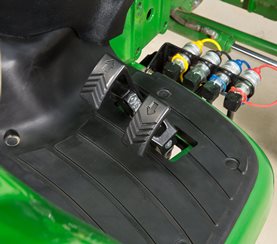 Twin Touch foot controls
Twin Touch foot controls
John Deere's Twin Touch foot controls offer several key advantages over competitive hydrostatic transmission (HST) tractor models.
Key advantages over competitive HST tractor models:
- Some competitive hydrostatic tractors use a treadle pedal (toe-heel) design foot control for operation
- Requires the operator to use both toe and heel to change direction, resulting in increased operator fatigue.
Integrated eHydro features
The eHydro convenience controls have been integrated into a single module. Combining features such as SpeedMatch™ LoadMatch™, MotionMatch™ eThrottle™ and automotive style cruise control pulls the maximum efficiency out of the eHydro transmission tractors. All of these features are standard on the 3R models, and deliver an easier and more comfortable user experience.
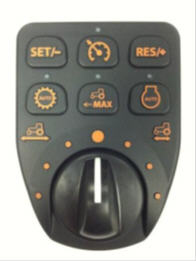 eHydro convenience control module
eHydro convenience control module

eThrottle
 eThrottle indicator
eThrottle indicator

The 3R Series Tractors come equipped with the eThrottle function. This feature is designed make the tractor quieter and use less fuel. With the simple push of a button, the engine speed will be linked to the pedal position. The operator can keep the throttle essentially all the way in the low position. The engine rpms, as well as the tractor speed, will increase together with the pedal position. This provides the operator with comfort and convenience as well as fuel economy.
 MotionMatch indicator
MotionMatch indicator

Shorter accelerate and decelerate distances.
Automotive-style cruise control
 Cruise control indicator
Cruise control indicator

An automotive-style cruise control is standard equipment on the 3R Series Tractors. Cruise control is electronically engaged and disengaged and is located on the right-hand operator console.
- Maintains desired forward speed without pressure on the foot pedal
- When activated, operator is able to set cruise speed
- Use the SET/- button to set cruise speed, or to decrease cruise/max speed
- Use the RES/+ button to set cruise speed, or to increase cruise/max speed
- A speed sensor also allows the tractor to maintain preset speed driving up and down hills
- To disengage the cruise control, either:
- Apply pressure to the brakes
- Disengage cruise control button
- Briefly depress the reverse travel pedal
LoadMatch power management system
 LoadMatch indicator
LoadMatch indicator

LoadMatch is an industry exclusive and a standard feature on the 3R Series Tractors.
If torque requirements increase significantly, the transmission will reduce the tractor's drive speed to compensate for the increased load on the transmission, maximizing torque to drive wheels and minimize stalls.
Controls automatically adjust LoadMatch compensation depending on the tractors application. PTO applications require less engine speed fluctuation, therefore adjusts the amount of droop depending on PTO speed. This adjustment increases efficiency and optimizes engine speed and torque output based on tractor application.
While typically left on, LoadMatch can be turned off with the right-hand console controls.
MotionMatch
The MotionMatch, standard on the 3R Series Tractors, is located on the right-hand console. It offers seven settings for adjusting the rollout or decelerate when the pedal is released.
 MotionMatch indicator
MotionMatch indicator

Longer accelerate and decelerate distances.
SpeedMatch
 SpeedMatch indicator
SpeedMatch indicator

SpeedMatch, standard on the 3R Series Tractors, further enhances the eHydro cruise control functions by allowing the operator to preset maximum speed. Once this feature is engaged, the operator must stroke the travel pedal fully to meet the operator preset speed. This function will improve accuracy and safety, particularly at lower travel speed applications.
Rotary tilling or spraying applications are examples of where SpeedMatch can be applied. SpeedMatch will work in both the forward and reverse set speeds.
NOTE: Automotive-style cruise control and SpeedMatch can be used in conjunction with LoadMatch to maximize productivity.
Sauer-Danfoss is a registered trademark of Sauer-Danfoss, Inc.
PowrReverser™ transmission allows for clutchless direction changes
The PowrReverser transmission, available on 3033R and 3039R Tractors, offers a hydraulically-shifted forward-to-reverse transmission. This allows for clutchless shuttle shifting between forward and reverse with one lever for quick and easy direction change.
- The PowrReverser transmission does not require the operator to use the clutch to shift between forward and reverse
The 12x12 PowrReverser transmission's hydraulically-actuated wet clutch takes the place of the dry-type traction clutch. Two multi-disk clutch packs (one forward and one reverse) are hydraulically actuated when the directional (reverser) lever is placed in either the forward or reverse position.
Each clutch pack consists of three large, 13-cm (5-in.) diameter clutch disks that are oil-cooled, allowing excellent heat dissipation and extended clutch life.
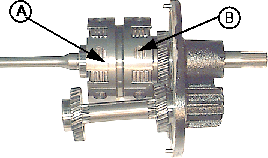 Forward/reverse clutches
Forward/reverse clutches
- Clutch A is used for the forward operation of the tractor
- Clutch B is used for the reverse operation of the tractor
Key features of the PowrReverser are:
-
12 forward and 12 reverse speeds
- Reverser lever, located on the left side on the instrument console, allows operator to make direction changes without clutching
- Fast shuttle shift for improved loader operation
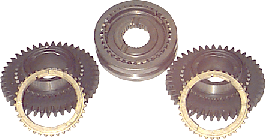 Helical-cut gears
Helical-cut gears
- Dual-cone synchronizers allow for synchronized shifts between gears for on-the-go shifting with use of the clutch
- Helical-cut gears for quiet operation
- Well-spaced speeds for turf, loader, and transport work
- Neutral-start switch prevents tractor from starting when transmission (main range) is not in neutral
- Dual wet-disk clutches provide long clutch life
- Shifts between ranges are not synchronized
NOTE: 3R Tractors with PowrReverser ARE NOT compatible with mid PTO. They are not compatible from the factory or field installed.
Operator station is comfortable and convenient
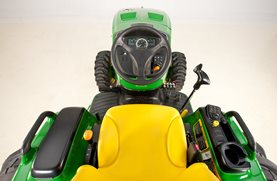 3R operator's station
3R operator's station
The operator's station is designed for easy entry to/exit from the tractor.
Conveniently placed pedals, as well as repositioned operator controls, provide for a clean and flat platform design, giving the operator plenty of legroom.
- Hood and fenders are made from composite polymer material designed to eliminate the possibility of rusting and resistance to dents, that can occur with metal hoods and fenders. This material provides a high-luster appearance with excellent resilience and resistance to fading from sunlight.
- Easy-fold rollover protective structure (ROPS), with built-in, rattle-reducing isolator.
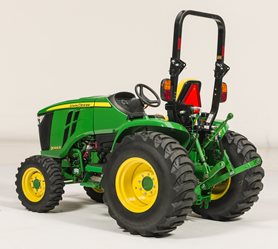 Safety certified folding ROPS
Safety certified folding ROPS
 Safety certified folding ROPS
Safety certified folding ROPS
Key features of the operator's station include:
- Large grab handles on each fender make getting on and off of the tractor easy
- Tilt steering wheel design in base equipment. The tilt wheel:
- Allows the operator to adjust the steering wheel to the most comfortable position
- Provides additional clearance for the operator to enter and exit the tractor
- Provides easy return to the fully raised position
- Provides plenty of room for comfortable operation
- Updated M-B-R power take-off (PTO) selector lever is standard equipment and allows independent control of the mid and rear PTO
- Controls are shape and color coded for easier identification and operation
- Easy-fold ROPS include a built in isolator for rattle free operation
- A left-side step is in base equipment to enhance access to the operator’s station
- Foot platform is rubber mounted and incorporates a runner mat for operator comfort
- PowrReverser™ models have both hand and foot throttle controls
- Throttle controls are especially handy when using a loader
Optional premium ComfortGard™ cab provides superior comfort and performance
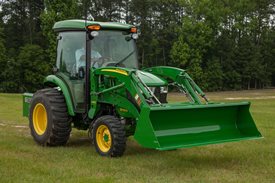 3R ComfortGard cab
3R ComfortGard cab

John Deere ComfortGard cab tractors are some of the most comfortable, quiet, and easy-to-use cab tractors available anywhere. This premium solution was developed using extensive customer research and validation tools, and some of the most advanced design techniques available.
The following ComfortGard cab tractor models are available:
- 3033R Tractor with hydrostatic transmission (HST)
- 3039R Tractor with HST
- 3046R Tractor with HST
Cab tractors are designed for those operators who demand superior performance.
- Large-property owners
- Commercial operators
- Governmental agencies
- Farmers
Whether doing loader work, front implement work (such as snow removal), mowing, tilling, rotary cutting, or light hay work, the cab tractors have the versatility and muscle to get the job done, all while protecting the operator from the elements.
Design
 State-of-the-art design
State-of-the-art design
 State-of-the-art design
State-of-the-art design
- Designed by John Deere and built at the John Deere factory in Ramos, Mexico
- Certified to the highest safety standards in the industry
- Fingertip controls and an automotive-like fit and finish
Operators are sure to appreciate what this cab has to offer — beginning with an isolated cab. These cabs are designed with robust mounting points integrated into the rollover protective structure (ROPS) with a unique offset mounting design that provides an ultra-quiet ride.
The 4-post ROPS design, carefully laid-out interior, and fuel tank located under the left rear side of the operator's platform provide a full 360 degrees of visibility.
- Operators enjoy a commanding view no matter what task is being performed.
- The raised header bar design allows operators — whether short or tall — to see the loader bucket or pallet forks through virtually the full range of operation.
- Operator fatigue caused by awkward bending is reduced, leading to increased overall productivity.
- The slow-moving vehicle (SMV) sign can be easily removed and stored in the operator's manual holder to provide a clear and unobstructed view for attaching to implements and doing field work.
- The ample headroom and curved glass on all four sides provide a spacious interior and give operators the feel of a big-tractor cab.
Operators are well-protected from the elements with a high-performance climate-control system providing heating and air conditioning.
- The climate-controlled cab makes any task more enjoyable whether on a frigid winter day or a hot summer day.
- The cab is completely sealed and pressurized to further protect the operator from the elements.
- A standard high-efficiency clean-air filter keeps even the smallest dust and allergen particles out.
Cab comfort features
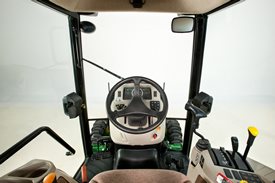 Superior operator comfort and visibility
Superior operator comfort and visibility
 Optional radio kit
Optional radio kit
Several features are integrated into the design of the cab that deliver superior operator comfort and visibility. These features include:
- Ultra-quiet interior
- Four-post ROPS with curved glass for 360-degree visibility and spacious interior
- Improved climate-control system for maximum operator comfort
- Raised header bar for maximum loader visibility
- Right-hand control center with the most frequently used controls at the operator's fingertips
- Left-hand automotive-style park brake
- Dash-mounted 4WD engagement, no awkward bending
- Tilt steering
- Improved shift range linkage for ease in operation
- Flat unobstructed foot platform
- In base equipment, deluxe cloth seat with a retractable seat belt and armrests for excellent back support
- Standard armrests for additional operator comfort
- Factory-installed deluxe air-ride seat with an adjustable backrest and adjustable armrests, available on the 3046R
- Inside rearview mirror for rear visibility
- Optional dual exterior rearview mirrors for added rear visibility
- Ergonomically placed integrated loader joystick control for maximum comfort during operation
- Interior dome light with on, door, and off positions for illumination in low-light conditions
- Optional factory or field-installed stereo with Jensen® receiver, weather band, powered USB port, and iPod® compatibility
- SWJHD1630 stereo with AM/FM, weatherband, SIRIUS® Satellite, and iPod ready can be ordered separately through Parts
- Standard sun visor to block unwanted sunlight
- Creature comforts like:
- Dual cup holders
- 12-V power supply
- Cell phone storage
- CD storage
- Hitch pin storage
- Miscellaneous storage
- Operator's manual holder
- Integrated handle providing support for ingress and egress
- Left-side step for convenient ingress and egress
Cab operating features
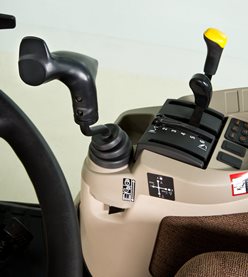 Right-hand control panel
Right-hand control panel
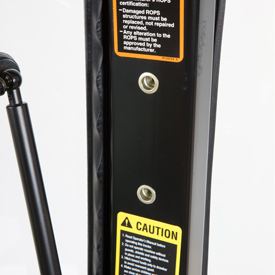 Side-post mounting bosses
Side-post mounting bosses
 Installing rear window removable plug
Installing rear window removable plug
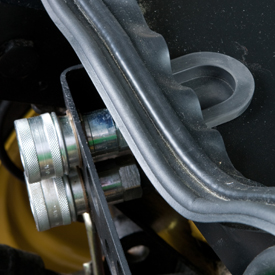 Rear window removable plug installed
Rear window removable plug installed
- Pre-wired for optional accessories like a radio, horn, rear work lights, electric hydraulic diverter, rear wiper/washer, beacon light, and cigarette lighter
- Integrated warning lights/turn signals and taillights, protected from trees and branches
- Integrated roof-mounted antenna, protected from potential damage from trees and branches
- Dual roof-mounted forward work lights for optimum forward visibility at night
- Standard two-speed front windshield wiper to keep the front glass clear
- Optional rear wiper/washer to keep the rear glass clear
- Optional front fenders to protect the front cab glass from mud and debris
- Optional rear fender extensions to help protect doors from mud and debris
- High-impact polymer fenders, dent resistant and painted to an automotive-like finish
- Rear glass that swings out 70 degrees for ventilation or access to the optional iMatch™ hitch
- Easy access to route and mount a controller or monitor through the rear window removable plug and mounting bosses on the side post
- Large, 48.5-L (12.8-gal.) fuel tank for longer operation without re-fuelling
- Left rear fender fuel fill with large opening for easy re-fuelling
- Fuel tank located under the left side of the operator's station for maximum rear visibility
Cab safety features
-
ROPS — Certified to the highest industry standards for maximum operator protection
-
Operator presence system
-
Engine shuts down if the operator leaves the seat when the transmission, mid, or rear PTO is engaged
-
Tractor must be in neutral and the park brake fully set for stationary PTO work
-
Right-side emergency exit
-
Tempered safety glass in case of breakage
-
Roof-mounted warning lights/turn signals for road transport — two front and two rear
-
Two fender-mounted taillights
-
Easily remove the slow-moving vehicle sign and store it in the operator's manual holder
Optional lighting includes:
-
Dual roof-mounted adjustable rear work lights
-
Rotating beacon light
Jensen is a U.S.-registered trademark of ASA Electronics Corporation. iPod is a U.S.-registered trademark of Apple Incorporated. SIRIUS is a U.S.-registered trademark of SIRIUS XM Radio Inc.
Deluxe cloth seat
A deluxe cloth seat with retractable seat belt is in base equipment.
-
An ergonomically sculpted seat cushion, an adjustable scissor-link suspension, and seat armrests are combined to provide excellent operator comfort and support.
-
The scissor-link suspension can be adjusted for the operator's height and weight.
-
The operator weight adjustment adjusts to the operator's weight (52 kg to 125 kg [115 lb to 275 lb]).
-
Using a lever located under the seat, the seat is adjustable fore and aft for operator height.
-
Retractable seat belts prevent belts from becoming tangled in the seat suspension and controls.
-
Optional air-suspension seat is available.
Optional air-suspension seat
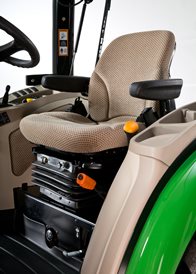 Air-suspension seat
Air-suspension seat

Two air-ride seat options are possible in 3R cab models. Both utilize the same suspension, which is designed to provide an air cushion for vertical-seat travel. This provides maximum operator comfort in any terrain. The two options are:
1. The optional factory-installed air-ride seat with a deluxe cloth two-piece seat with adjustable backrest and integrated armrests (for the 3046R only).
Seat features:
- Push the button at the base of the seat to pump up the seat. Pull the button to deflate the seat.
- The seat slides fore/aft with a lever on the right-hand side of the seat.
- The seat back reclines with a lever in the lower left corner of seat cushion.
- Upper backrest extension available as a field installed option.
2. The optional field-installed air suspension kit that requires the existing standard seat to be re-used when installed.
NOTE: The deluxe two-piece seat top can be ordered through Parts for customers who desire it.
Key benefits include:
- Maximum ride comfort and quality, thus minimizing operator fatigue
- Dampens lower frequency vibration better than mechanical suspensions
- Operator weight capacity of 330 lb
- Enhanced appearance with the close-out boot
Lighting equipment
The base lighting package for cab tractors includes:
- Two wide-angle halogen headlights
- Two roof-mounted, adjustable halogen forward work lights, illuminating the work area in nighttime or low-light conditions
- Two front and two rear amber turn signals/warning lights integrated into the cab roof
- Two taillights integrated into the fenders
- Three-position (on/off/auto) interior dome light
Optional lighting
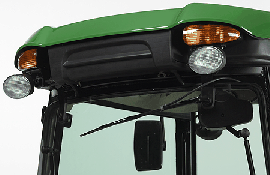 Optional lighting
Optional lighting
Built-in safety features for operator peace of mind
Safety is designed into all 3R Series Tractors.
- Operator presence system ensures the operator is in the seat to operate the tractor
- Roll-over protective structure (ROPS) is designed for operation safety
- Reflective ROPS strips for better tractor visibility
- Key switch interlock prevents bypass starting
- Visual power take-off (PTO) warning light alerts operator when either mid or rear PTO is running
- Reverse implement option (RIO) for safe mid-PTO operation
- Placing the transmission in neutral and setting the park brake allows operator to run rear PTO safely when off the tractor seat
- Turn signal and flashing warning lights operate according to ASAE S279.10 standard
- Taillights for road transport
- Slow moving vehicle (SMV) sign for road transport
Optional iMatch™ Quick-Hitch feature allows for easy implement hookup
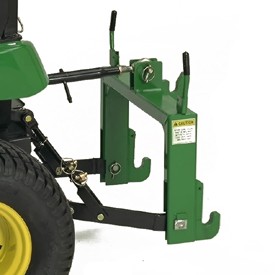 iMatch Quick-Hitch
iMatch Quick-Hitch
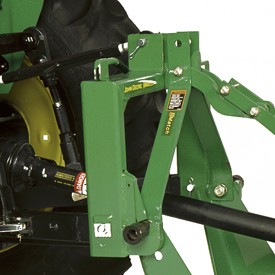 iMatch Quick-Hitch with rotary cutter hookup
iMatch Quick-Hitch with rotary cutter hookup
 iMatch Quick-Hitch (LVB25976)
iMatch Quick-Hitch (LVB25976)
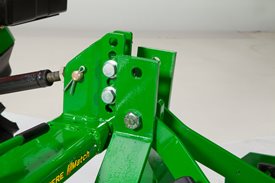 iMatch Quick-Hitch with rotary cutter hookup (LVB25976)
iMatch Quick-Hitch with rotary cutter hookup (LVB25976)
One of the greatest operator concerns involves difficulty in attaching tractor implements. John Deere has addressed this issue with the iMatch Quick-Hitch.
The iMatch Quick-Hitch provides easy hookup and a guaranteed fit for all Category 1 implements that are designed to meet the American Society of Agricultural and Biological Engineers (ASABE) Category 1 Standard S278.6 for quick-attach hitches.
- All implements require a set of bushings in order for the attachment to fit and work properly with the iMatch Quick-Hitch. One set of bushings comes with the iMatch Quick-Hitch.
NOTE: The bushing set can be seen in the picture above. These bushings allow the hooks on the iMatch and the pins on the implement to fit together properly. All other implements (box blades, tillers, rear blades, etc.) will require a set of bushings to enlarge the pin to fit with the iMatch hooks. Bushings of different lengths can be found in the parts system or through a bushing supplier (see dimensions below).
- Upper bushing
- Inside diameter: 1.93-1.95 cm (0.76-0.77 in.)
- Outside diameter: 3.15-3.18 cm (1.24-1.25 in.)
- Lower bushings
- Inside diameter: 2.24-2.26 cm (0.88 to 0.89 in.)
- Outside diameter: 3.63-3.66 cm (1.43 to 1.44 in.)
Excellent serviceability reduces operational costs and improves productivity
Regular service and maintenance are essential to the performance, productivity, and longevity of the tractor.
- Easy access to most regular service points minimizes service time.
- Tractors are equipped with extensive onboard self-diagnostic capabilities and are fully compatible with the John Deere-exclusive Service ADVISOR™ system.
- Daily service requirements are minimal and simple to accomplish. Most service interval requirements can be performed with a basic understanding of procedures and common tools.
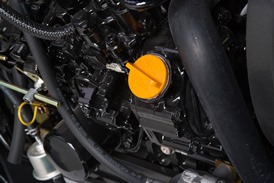 Removable side panels (previous model shown)
Removable side panels (previous model shown)

All items in the daily service schedule can be performed without the use of tools:
- Engine oil, hydraulic oil, coolant level, and the water separator can be conveniently accessed.
- The engine can be easily accessed by simply raising the hood for more periodic maintenance checks
- A single-point latch mechanism and self-contained leash ensure easy hood opening and closure.
NOTE: Always refer to the operator’s manual for complete maintenance and service recommendations.
Features
Attractive styling provides improved visibility and serviceability
 3R Open-Operator Station Tractor
3R Open-Operator Station Tractor

The bold styling of the tractor provides an attractive and functional appearance similar to that of the larger agricultural tractors. Benefits of this styling include:
- Easy tractor family identification
- Updated fixed grill and side panel hood design allowing for optimum sealing of the cooling compartment
- Integrated maintenance position on front grill for easy battery access
- Wraparound-style halogen headlights
- Premium integrated automotive style headlight bezels
- Bold graphics allowing for easy tractor family identification
- Aggressively sloped hood design giving a softer, smoother look, and providing improved visibility
- Hybrid exhaust in base for clear operator visibility and safety
The result gives the tractor a distinctive appearance and feel.
NOTE: If tractor is equipped with optional field-installed vertical exhaust, exhaust pipe must be removed before opening and closing the hood of the tractor.
Powerful Yanmar® diesel engine delivers plenty of power under heavy loads
 Yanmar 3-Cylinder, TNV Series diesel engine
Yanmar 3-Cylinder, TNV Series diesel engine
The Yanmar 3-cylinder, TNV series diesel engine features a high torque reserve that provides plenty of power under heavy loads.
This engine features lower levels of exhaust emissions and reduced noise levels. The engine meets all current Environmental Protection Agency (EPA) emission requirements for Final Tier 4 emission standards.
The 1.642-L displacement, naturally aspirated, 3TNV88C Yanmar diesel engine provides 31.8 hp to the 3033R Tractor.
Model |
Number of |
Engine |
Rated rpm |
Gross engine hp* |
Gross engine ps* |
PTO hp* |
3033R |
3 |
1.642L |
2600 |
31.8 |
32.2 |
23.6 |
*Engine hp (kW), gross SAE J1995: 32.2 (23.7) at 2600 rpm, PS
Displacement, in3 (L):100.2 (1.642)
3039R
The 1.496-L, turbocharged, 3TNV86CT CR Yanmar diesel engine provides 38.2 hp to the 3039R Tractor.
Model |
Number of |
Engine |
Rated rpm |
Gross engine hp* |
Gross engine ps* |
PTO hp* |
3039R |
3 |
1.496L |
2600 |
38.2 |
38.7 |
31.3 |
*Engine hp (kW), gross SAE J1995: 38.7 (28.5) at 2600 rpm, PS
Displacement, in3 (L): 95.7 (1.568)
3046R
The 1.496-L, turbocharged, intercooled 3TNV86CHT CR Yanmar diesel engine provides 44.7 hp to the 3046R Tractor.
Model |
Number of |
Engine |
Rated rpm |
Gross engine hp* |
Gross engine ps* |
PTO hp* |
3046R |
3 |
1.496L |
2600 |
44.7 |
45.3 |
34.1 |
*Engine hp (kW), gross SAE J1995: 45.3 (33.34) at 2600 rpm, PS
Displacement, in3 (L): 91.3 (1.496)
The engine uses latest technologies to optimize fuel economy, improve control and accuracy, and reduces environmental impact.
The common rail system (CRS) optimizes fuel economy and reduces operating costs*. High pressure injection atomizes fuel into finer particles which burn more completely. It results in improved fuel economy and lower cost of operation.
The electronic control unit (ECU) provides optimum fuel control and accuracy. ECU monitors and controls the engine. It continuously monitors engine conditions and adjusts the fuel delivery accordingly to ensure optimum performance and emissions.
The new engine comes with an after treatment system. The system operates automatically. The exhaust filter consists of a diesel particulate filter (DPF) which captures particulate matter (PM) contained in the exhaust gas. Using a natural cleaning process, most of the PM trapped in the exhaust filter is eliminated by the heat of the exhaust stream generated by normal use. In situations of low temperature, engine speed or load factor, an active cleaning cycle is initiated. In this cleaning cycle, the exhaust gas temperature is raised by injecting additional fuel during the exhaust stroke of normal vehicle operation to the diesel oxidation catalyst (DOC).
After many hours of use, the exhaust filter may require an ash removal service.
NOTE: *As compared to engines not using CRS technology.
DPF cleaning
Depending on the load that the tractor is under, as well as ambient temperature, humidity, and engine speed, the DPF may build up with particulate matter, thus requiring cleaning. Filter cleaning is determined by one of three conditions:
- A prescribed time-based estimation of needed filter cleaning
- DOC/DPF pressure sensors
- A particulate matter buildup estimation based on load conditions
Once one of the three conditions has been met, filter cleaning will occur.
There are three different types of filter cleaning processes:
- Passive filter cleaning
- Active filter cleaning
- Parked filter cleaning
Passive filter cleaning
Passive filter cleaning occurs naturally when the engine is generating enough heat to oxidize particulate matter. This automatic process occurs continuously during normal operating conditions. No tractor icons or symbols appear on the display during passive filter cleaning.
NOTE: Passive filter cleaning requires no operator involvement, and there is no interruption to tractor operation.
Active filter cleaning
If conditions (temperature, load, or speed) for passive filter cleaning cannot be achieved, then PM is removed using active filter cleaner.
To achieve the required conditions, exhaust temperature management (ETM) manages the initiation and duration of active filter cleaning. ETM can adjust numerous engine parameters and/or inject a small quantity of fuel into the exhaust stream for a short duration. The fuel turns to vapor and chemically reacts with the catalysts in the DOC to create heat to oxidize PM.
It is important to note that at no time is the fuel in the DOC/DPF ignited, and there is no flame within the DOC/DPF.
Like passive filter cleaning, active filter cleaning requires no operator involvement, and there is no interruption to tractor operation.
Parked filter cleaning
In some instances where passive and active filter cleaning have not fully cleaned the PM from the system, a parked filter cleaning may need to take place. Most likely, the only time a parked filter cleaning will need to occur is when automatic filter cleaning has been disabled for an extended period of time and multiple warnings to engage filter cleaning were ignored or if the tractor has been used during light load conditions. Additionally, when the automatic filter cleaning process has been deliberately interrupted multiple times, or if active filter cleaning has failed numerous times due to a failed component, a parked filter cleaning may be requested. In these rare instances the operator will have to park the tractor and start the filter cleaning process.
The parked filter cleaning process needs to be activated based on usage and operation of the tractor. The process will take approximately 30 minutes. See operator’s manual for more details.
This system constantly monitors the soot level of the tractor, making sure the tractor is always in peak performance condition. This ensures high performance at all times.
NOTE: Number of hours since last regeneration and soot level percentage viewable on LCD display.
NOTE: When the tractor is in a filter cleaning process at low speed or while parked and running, the exhaust will be routed through the vertical exhaust outlet. In all other cases, the exhaust will be routed through the downward exhaust outlet. This ensures minimal heat impact to operator.
Key features of the engine are:
- Economical cast-in-block cylinder design for good cooling and long life
- Direct fuel injection
- Improves starting
- Injects fuel directly on top of pistons for more efficient combustion
- Develops more horsepower per gallon of fuel than indirect injection engines
- Aluminum alloy pistons with built-in steel struts are lightweight to reduce connecting rod-bearing loads and provide good heat transfer characteristics
- Design permits tighter tolerances and neutralizes expansion of the piston, which reduces blow-by and noise from piston slap
- Top rings are higher on the piston and a thinner head gasket is used to greatly reduce the volume of unburned waste gases and increase combustion efficiency
- Timing gears and injector drive gears have a helical profile to reduce engine noise
- Auto-bleed fuel system
- There is no need to prime the system if the tractor runs out of fuel
- The system will self-prime the injection pump, lines and injectors, providing fast fuel recovery for easier starting
- Key start and shutoff eliminates fuel shutoff knob
- Electric solenoid shuts fuel supply off immediately when key is turned off
- Fuel filter with replaceable element
- Water separator
- See-through coolant recovery tank permits operator to check coolant level without removing radiator cap
- Sealed radiator compartment keeps trash and debris on outside of hood
 Dry-type air cleaner
Dry-type air cleaner

- Dry-type air cleaner with safety element and electronic air service indicator
- Electronic air restriction indicator alerts operator when air filter servicing is required
- Dual element design for added engine protection
- Easy to service
- Hybrid exhaust
- Discharges fumes away from the operator and reduces noise from engine
- Improves operator visibility
- Optional vertical exhaust kit is available
- In normal operations, the exhaust goes through the downward exhaust outlet
- In park regeneration process, the exhaust will go through the upward exhaust outlet
Yanmar is a trademark of Yanmar Company Limited.
Maximize productivity with an eHydro™ transmission
The 3R Series Tractor is available with an exclusive three-range electronic hydrostatic (eHydro) transmission.
- Fluid under pressure transmits engine power to the drive wheels through a pump and motor
- Provides high torque for start-up
- Reduces powertrain shock loads
Sauer-Danfoss® supplies both the pump and motor. This ensures that the components are matched to each other, providing maximum efficiency.
The electronic hydrostatic transmission is ideally suited for jobs where productivity is a must, such as loader or mower applications.
Twin Touch™ foot controls allow selecting both direction of travel and speed with a touch of the toe.
Key features of the eHydro transmission are:
- Infinite ground speeds, even at full throttle, allow the operator to match the speed of the tractor to the job
- No clutching for fast and easy direction changes
- Twin Touch foot pedals for quick and easy forward/reverse operation
- Cruise control is base equipment
- Cruise-control switch is located on the right-hand console for easy access
- Cruise control is electronically engaged and disengaged and allows for more precise setting of speed
Sauer-Danfoss eHydro transmission is used for reliable operation. Durability features include:
1) Large forged trunnion shaft with larger support bearings to reduce vibration and noise.
2) Center section made from durable cast aluminum, which is 10 percent stronger.
3) Transmission oil cooler cools transmission oil for longer transmission life.
Safety features of the eHydro transmission include:
- The tractor will start with one or both foot pedals depressed, but it will not move until both pedals first come to neutral
- The tractor will come to a stop if the operator leaves the seat but the engine will not shut off unless the power take-off (PTO) is also running
Key John Deere advantage
 Twin Touch foot controls
Twin Touch foot controls
John Deere's Twin Touch foot controls offer several key advantages over competitive hydrostatic transmission (HST) tractor models.
Key advantages over competitive HST tractor models:
- Some competitive hydrostatic tractors use a treadle pedal (toe-heel) design foot control for operation
- Requires the operator to use both toe and heel to change direction, resulting in increased operator fatigue.
Integrated eHydro features
The eHydro convenience controls have been integrated into a single module. Combining features such as SpeedMatch™ LoadMatch™, MotionMatch™ eThrottle™ and automotive style cruise control pulls the maximum efficiency out of the eHydro transmission tractors. All of these features are standard on the 3R models, and deliver an easier and more comfortable user experience.
 eHydro convenience control module
eHydro convenience control module

eThrottle
 eThrottle indicator
eThrottle indicator

The 3R Series Tractors come equipped with the eThrottle function. This feature is designed make the tractor quieter and use less fuel. With the simple push of a button, the engine speed will be linked to the pedal position. The operator can keep the throttle essentially all the way in the low position. The engine rpms, as well as the tractor speed, will increase together with the pedal position. This provides the operator with comfort and convenience as well as fuel economy.
 MotionMatch indicator
MotionMatch indicator

Shorter accelerate and decelerate distances.
Automotive-style cruise control
 Cruise control indicator
Cruise control indicator

An automotive-style cruise control is standard equipment on the 3R Series Tractors. Cruise control is electronically engaged and disengaged and is located on the right-hand operator console.
- Maintains desired forward speed without pressure on the foot pedal
- When activated, operator is able to set cruise speed
- Use the SET/- button to set cruise speed, or to decrease cruise/max speed
- Use the RES/+ button to set cruise speed, or to increase cruise/max speed
- A speed sensor also allows the tractor to maintain preset speed driving up and down hills
- To disengage the cruise control, either:
- Apply pressure to the brakes
- Disengage cruise control button
- Briefly depress the reverse travel pedal
LoadMatch power management system
 LoadMatch indicator
LoadMatch indicator

LoadMatch is an industry exclusive and a standard feature on the 3R Series Tractors.
If torque requirements increase significantly, the transmission will reduce the tractor's drive speed to compensate for the increased load on the transmission, maximizing torque to drive wheels and minimize stalls.
Controls automatically adjust LoadMatch compensation depending on the tractors application. PTO applications require less engine speed fluctuation, therefore adjusts the amount of droop depending on PTO speed. This adjustment increases efficiency and optimizes engine speed and torque output based on tractor application.
While typically left on, LoadMatch can be turned off with the right-hand console controls.
MotionMatch
The MotionMatch, standard on the 3R Series Tractors, is located on the right-hand console. It offers seven settings for adjusting the rollout or decelerate when the pedal is released.
 MotionMatch indicator
MotionMatch indicator

Longer accelerate and decelerate distances.
SpeedMatch
 SpeedMatch indicator
SpeedMatch indicator

SpeedMatch, standard on the 3R Series Tractors, further enhances the eHydro cruise control functions by allowing the operator to preset maximum speed. Once this feature is engaged, the operator must stroke the travel pedal fully to meet the operator preset speed. This function will improve accuracy and safety, particularly at lower travel speed applications.
Rotary tilling or spraying applications are examples of where SpeedMatch can be applied. SpeedMatch will work in both the forward and reverse set speeds.
NOTE: Automotive-style cruise control and SpeedMatch can be used in conjunction with LoadMatch to maximize productivity.
Sauer-Danfoss is a registered trademark of Sauer-Danfoss, Inc.
PowrReverser™ transmission allows for clutchless direction changes
The PowrReverser transmission, available on 3033R and 3039R Tractors, offers a hydraulically-shifted forward-to-reverse transmission. This allows for clutchless shuttle shifting between forward and reverse with one lever for quick and easy direction change.
- The PowrReverser transmission does not require the operator to use the clutch to shift between forward and reverse
The 12x12 PowrReverser transmission's hydraulically-actuated wet clutch takes the place of the dry-type traction clutch. Two multi-disk clutch packs (one forward and one reverse) are hydraulically actuated when the directional (reverser) lever is placed in either the forward or reverse position.
Each clutch pack consists of three large, 13-cm (5-in.) diameter clutch disks that are oil-cooled, allowing excellent heat dissipation and extended clutch life.
 Forward/reverse clutches
Forward/reverse clutches
- Clutch A is used for the forward operation of the tractor
- Clutch B is used for the reverse operation of the tractor
Key features of the PowrReverser are:
-
12 forward and 12 reverse speeds
- Reverser lever, located on the left side on the instrument console, allows operator to make direction changes without clutching
- Fast shuttle shift for improved loader operation
 Helical-cut gears
Helical-cut gears
- Dual-cone synchronizers allow for synchronized shifts between gears for on-the-go shifting with use of the clutch
- Helical-cut gears for quiet operation
- Well-spaced speeds for turf, loader, and transport work
- Neutral-start switch prevents tractor from starting when transmission (main range) is not in neutral
- Dual wet-disk clutches provide long clutch life
- Shifts between ranges are not synchronized
NOTE: 3R Tractors with PowrReverser ARE NOT compatible with mid PTO. They are not compatible from the factory or field installed.
Operator station is comfortable and convenient
 3R operator's station
3R operator's station
The operator's station is designed for easy entry to/exit from the tractor.
Conveniently placed pedals, as well as repositioned operator controls, provide for a clean and flat platform design, giving the operator plenty of legroom.
- Hood and fenders are made from composite polymer material designed to eliminate the possibility of rusting and resistance to dents, that can occur with metal hoods and fenders. This material provides a high-luster appearance with excellent resilience and resistance to fading from sunlight.
- Easy-fold rollover protective structure (ROPS), with built-in, rattle-reducing isolator.
 Safety certified folding ROPS
Safety certified folding ROPS
 Safety certified folding ROPS
Safety certified folding ROPS
Key features of the operator's station include:
- Large grab handles on each fender make getting on and off of the tractor easy
- Tilt steering wheel design in base equipment. The tilt wheel:
- Allows the operator to adjust the steering wheel to the most comfortable position
- Provides additional clearance for the operator to enter and exit the tractor
- Provides easy return to the fully raised position
- Provides plenty of room for comfortable operation
- Updated M-B-R power take-off (PTO) selector lever is standard equipment and allows independent control of the mid and rear PTO
- Controls are shape and color coded for easier identification and operation
- Easy-fold ROPS include a built in isolator for rattle free operation
- A left-side step is in base equipment to enhance access to the operator’s station
- Foot platform is rubber mounted and incorporates a runner mat for operator comfort
- PowrReverser™ models have both hand and foot throttle controls
- Throttle controls are especially handy when using a loader
Optional premium ComfortGard™ cab provides superior comfort and performance
 3R ComfortGard cab
3R ComfortGard cab

John Deere ComfortGard cab tractors are some of the most comfortable, quiet, and easy-to-use cab tractors available anywhere. This premium solution was developed using extensive customer research and validation tools, and some of the most advanced design techniques available.
The following ComfortGard cab tractor models are available:
- 3033R Tractor with hydrostatic transmission (HST)
- 3039R Tractor with HST
- 3046R Tractor with HST
Cab tractors are designed for those operators who demand superior performance.
- Large-property owners
- Commercial operators
- Governmental agencies
- Farmers
Whether doing loader work, front implement work (such as snow removal), mowing, tilling, rotary cutting, or light hay work, the cab tractors have the versatility and muscle to get the job done, all while protecting the operator from the elements.
Design
 State-of-the-art design
State-of-the-art design
 State-of-the-art design
State-of-the-art design
- Designed by John Deere and built at the John Deere factory in Ramos, Mexico
- Certified to the highest safety standards in the industry
- Fingertip controls and an automotive-like fit and finish
Operators are sure to appreciate what this cab has to offer — beginning with an isolated cab. These cabs are designed with robust mounting points integrated into the rollover protective structure (ROPS) with a unique offset mounting design that provides an ultra-quiet ride.
The 4-post ROPS design, carefully laid-out interior, and fuel tank located under the left rear side of the operator's platform provide a full 360 degrees of visibility.
- Operators enjoy a commanding view no matter what task is being performed.
- The raised header bar design allows operators — whether short or tall — to see the loader bucket or pallet forks through virtually the full range of operation.
- Operator fatigue caused by awkward bending is reduced, leading to increased overall productivity.
- The slow-moving vehicle (SMV) sign can be easily removed and stored in the operator's manual holder to provide a clear and unobstructed view for attaching to implements and doing field work.
- The ample headroom and curved glass on all four sides provide a spacious interior and give operators the feel of a big-tractor cab.
Operators are well-protected from the elements with a high-performance climate-control system providing heating and air conditioning.
- The climate-controlled cab makes any task more enjoyable whether on a frigid winter day or a hot summer day.
- The cab is completely sealed and pressurized to further protect the operator from the elements.
- A standard high-efficiency clean-air filter keeps even the smallest dust and allergen particles out.
Cab comfort features
 Superior operator comfort and visibility
Superior operator comfort and visibility
 Optional radio kit
Optional radio kit
Several features are integrated into the design of the cab that deliver superior operator comfort and visibility. These features include:
- Ultra-quiet interior
- Four-post ROPS with curved glass for 360-degree visibility and spacious interior
- Improved climate-control system for maximum operator comfort
- Raised header bar for maximum loader visibility
- Right-hand control center with the most frequently used controls at the operator's fingertips
- Left-hand automotive-style park brake
- Dash-mounted 4WD engagement, no awkward bending
- Tilt steering
- Improved shift range linkage for ease in operation
- Flat unobstructed foot platform
- In base equipment, deluxe cloth seat with a retractable seat belt and armrests for excellent back support
- Standard armrests for additional operator comfort
- Factory-installed deluxe air-ride seat with an adjustable backrest and adjustable armrests, available on the 3046R
- Inside rearview mirror for rear visibility
- Optional dual exterior rearview mirrors for added rear visibility
- Ergonomically placed integrated loader joystick control for maximum comfort during operation
- Interior dome light with on, door, and off positions for illumination in low-light conditions
- Optional factory or field-installed stereo with Jensen® receiver, weather band, powered USB port, and iPod® compatibility
- SWJHD1630 stereo with AM/FM, weatherband, SIRIUS® Satellite, and iPod ready can be ordered separately through Parts
- Standard sun visor to block unwanted sunlight
- Creature comforts like:
- Dual cup holders
- 12-V power supply
- Cell phone storage
- CD storage
- Hitch pin storage
- Miscellaneous storage
- Operator's manual holder
- Integrated handle providing support for ingress and egress
- Left-side step for convenient ingress and egress
Cab operating features
 Right-hand control panel
Right-hand control panel
 Side-post mounting bosses
Side-post mounting bosses
 Installing rear window removable plug
Installing rear window removable plug
 Rear window removable plug installed
Rear window removable plug installed
- Pre-wired for optional accessories like a radio, horn, rear work lights, electric hydraulic diverter, rear wiper/washer, beacon light, and cigarette lighter
- Integrated warning lights/turn signals and taillights, protected from trees and branches
- Integrated roof-mounted antenna, protected from potential damage from trees and branches
- Dual roof-mounted forward work lights for optimum forward visibility at night
- Standard two-speed front windshield wiper to keep the front glass clear
- Optional rear wiper/washer to keep the rear glass clear
- Optional front fenders to protect the front cab glass from mud and debris
- Optional rear fender extensions to help protect doors from mud and debris
- High-impact polymer fenders, dent resistant and painted to an automotive-like finish
- Rear glass that swings out 70 degrees for ventilation or access to the optional iMatch™ hitch
- Easy access to route and mount a controller or monitor through the rear window removable plug and mounting bosses on the side post
- Large, 48.5-L (12.8-gal.) fuel tank for longer operation without re-fuelling
- Left rear fender fuel fill with large opening for easy re-fuelling
- Fuel tank located under the left side of the operator's station for maximum rear visibility
Cab safety features
-
ROPS — Certified to the highest industry standards for maximum operator protection
-
Operator presence system
-
Engine shuts down if the operator leaves the seat when the transmission, mid, or rear PTO is engaged
-
Tractor must be in neutral and the park brake fully set for stationary PTO work
-
Right-side emergency exit
-
Tempered safety glass in case of breakage
-
Roof-mounted warning lights/turn signals for road transport — two front and two rear
-
Two fender-mounted taillights
-
Easily remove the slow-moving vehicle sign and store it in the operator's manual holder
Optional lighting includes:
-
Dual roof-mounted adjustable rear work lights
-
Rotating beacon light
Jensen is a U.S.-registered trademark of ASA Electronics Corporation. iPod is a U.S.-registered trademark of Apple Incorporated. SIRIUS is a U.S.-registered trademark of SIRIUS XM Radio Inc.
Deluxe cloth seat
A deluxe cloth seat with retractable seat belt is in base equipment.
-
An ergonomically sculpted seat cushion, an adjustable scissor-link suspension, and seat armrests are combined to provide excellent operator comfort and support.
-
The scissor-link suspension can be adjusted for the operator's height and weight.
-
The operator weight adjustment adjusts to the operator's weight (52 kg to 125 kg [115 lb to 275 lb]).
-
Using a lever located under the seat, the seat is adjustable fore and aft for operator height.
-
Retractable seat belts prevent belts from becoming tangled in the seat suspension and controls.
-
Optional air-suspension seat is available.
Optional air-suspension seat
 Air-suspension seat
Air-suspension seat

Two air-ride seat options are possible in 3R cab models. Both utilize the same suspension, which is designed to provide an air cushion for vertical-seat travel. This provides maximum operator comfort in any terrain. The two options are:
1. The optional factory-installed air-ride seat with a deluxe cloth two-piece seat with adjustable backrest and integrated armrests (for the 3046R only).
Seat features:
- Push the button at the base of the seat to pump up the seat. Pull the button to deflate the seat.
- The seat slides fore/aft with a lever on the right-hand side of the seat.
- The seat back reclines with a lever in the lower left corner of seat cushion.
- Upper backrest extension available as a field installed option.
2. The optional field-installed air suspension kit that requires the existing standard seat to be re-used when installed.
NOTE: The deluxe two-piece seat top can be ordered through Parts for customers who desire it.
Key benefits include:
- Maximum ride comfort and quality, thus minimizing operator fatigue
- Dampens lower frequency vibration better than mechanical suspensions
- Operator weight capacity of 330 lb
- Enhanced appearance with the close-out boot
Lighting equipment
The base lighting package for cab tractors includes:
- Two wide-angle halogen headlights
- Two roof-mounted, adjustable halogen forward work lights, illuminating the work area in nighttime or low-light conditions
- Two front and two rear amber turn signals/warning lights integrated into the cab roof
- Two taillights integrated into the fenders
- Three-position (on/off/auto) interior dome light
Optional lighting
 Optional lighting
Optional lighting
Built-in safety features for operator peace of mind
Safety is designed into all 3R Series Tractors.
- Operator presence system ensures the operator is in the seat to operate the tractor
- Roll-over protective structure (ROPS) is designed for operation safety
- Reflective ROPS strips for better tractor visibility
- Key switch interlock prevents bypass starting
- Visual power take-off (PTO) warning light alerts operator when either mid or rear PTO is running
- Reverse implement option (RIO) for safe mid-PTO operation
- Placing the transmission in neutral and setting the park brake allows operator to run rear PTO safely when off the tractor seat
- Turn signal and flashing warning lights operate according to ASAE S279.10 standard
- Taillights for road transport
- Slow moving vehicle (SMV) sign for road transport
Optional iMatch™ Quick-Hitch feature allows for easy implement hookup
 iMatch Quick-Hitch
iMatch Quick-Hitch
 iMatch Quick-Hitch with rotary cutter hookup
iMatch Quick-Hitch with rotary cutter hookup
 iMatch Quick-Hitch (LVB25976)
iMatch Quick-Hitch (LVB25976)
 iMatch Quick-Hitch with rotary cutter hookup (LVB25976)
iMatch Quick-Hitch with rotary cutter hookup (LVB25976)
One of the greatest operator concerns involves difficulty in attaching tractor implements. John Deere has addressed this issue with the iMatch Quick-Hitch.
The iMatch Quick-Hitch provides easy hookup and a guaranteed fit for all Category 1 implements that are designed to meet the American Society of Agricultural and Biological Engineers (ASABE) Category 1 Standard S278.6 for quick-attach hitches.
- All implements require a set of bushings in order for the attachment to fit and work properly with the iMatch Quick-Hitch. One set of bushings comes with the iMatch Quick-Hitch.
NOTE: The bushing set can be seen in the picture above. These bushings allow the hooks on the iMatch and the pins on the implement to fit together properly. All other implements (box blades, tillers, rear blades, etc.) will require a set of bushings to enlarge the pin to fit with the iMatch hooks. Bushings of different lengths can be found in the parts system or through a bushing supplier (see dimensions below).
- Upper bushing
- Inside diameter: 1.93-1.95 cm (0.76-0.77 in.)
- Outside diameter: 3.15-3.18 cm (1.24-1.25 in.)
- Lower bushings
- Inside diameter: 2.24-2.26 cm (0.88 to 0.89 in.)
- Outside diameter: 3.63-3.66 cm (1.43 to 1.44 in.)
Excellent serviceability reduces operational costs and improves productivity
Regular service and maintenance are essential to the performance, productivity, and longevity of the tractor.
- Easy access to most regular service points minimizes service time.
- Tractors are equipped with extensive onboard self-diagnostic capabilities and are fully compatible with the John Deere-exclusive Service ADVISOR™ system.
- Daily service requirements are minimal and simple to accomplish. Most service interval requirements can be performed with a basic understanding of procedures and common tools.
 Removable side panels (previous model shown)
Removable side panels (previous model shown)

All items in the daily service schedule can be performed without the use of tools:
- Engine oil, hydraulic oil, coolant level, and the water separator can be conveniently accessed.
- The engine can be easily accessed by simply raising the hood for more periodic maintenance checks
- A single-point latch mechanism and self-contained leash ensure easy hood opening and closure.
NOTE: Always refer to the operator’s manual for complete maintenance and service recommendations.
Features
Attractive styling provides improved visibility and serviceability
 3R Open-Operator Station Tractor
3R Open-Operator Station Tractor

The bold styling of the tractor provides an attractive and functional appearance similar to that of the larger agricultural tractors. Benefits of this styling include:
- Easy tractor family identification
- Updated fixed grill and side panel hood design allowing for optimum sealing of the cooling compartment
- Integrated maintenance position on front grill for easy battery access
- Wraparound-style halogen headlights
- Premium integrated automotive style headlight bezels
- Bold graphics allowing for easy tractor family identification
- Aggressively sloped hood design giving a softer, smoother look, and providing improved visibility
- Hybrid exhaust in base for clear operator visibility and safety
The result gives the tractor a distinctive appearance and feel.
NOTE: If tractor is equipped with optional field-installed vertical exhaust, exhaust pipe must be removed before opening and closing the hood of the tractor.
Powerful Yanmar® diesel engine delivers plenty of power under heavy loads
 Yanmar 3-Cylinder, TNV Series diesel engine
Yanmar 3-Cylinder, TNV Series diesel engine
The Yanmar 3-cylinder, TNV series diesel engine features a high torque reserve that provides plenty of power under heavy loads.
This engine features lower levels of exhaust emissions and reduced noise levels. The engine meets all current Environmental Protection Agency (EPA) emission requirements for Final Tier 4 emission standards.
The 1.642-L displacement, naturally aspirated, 3TNV88C Yanmar diesel engine provides 31.8 hp to the 3033R Tractor.
Model |
Number of |
Engine |
Rated rpm |
Gross engine hp* |
Gross engine ps* |
PTO hp* |
3033R |
3 |
1.642L |
2600 |
31.8 |
32.2 |
23.6 |
*Engine hp (kW), gross SAE J1995: 32.2 (23.7) at 2600 rpm, PS
Displacement, in3 (L):100.2 (1.642)
3039R
The 1.496-L, turbocharged, 3TNV86CT CR Yanmar diesel engine provides 38.2 hp to the 3039R Tractor.
Model |
Number of |
Engine |
Rated rpm |
Gross engine hp* |
Gross engine ps* |
PTO hp* |
3039R |
3 |
1.496L |
2600 |
38.2 |
38.7 |
31.3 |
*Engine hp (kW), gross SAE J1995: 38.7 (28.5) at 2600 rpm, PS
Displacement, in3 (L): 95.7 (1.568)
3046R
The 1.496-L, turbocharged, intercooled 3TNV86CHT CR Yanmar diesel engine provides 44.7 hp to the 3046R Tractor.
Model |
Number of |
Engine |
Rated rpm |
Gross engine hp* |
Gross engine ps* |
PTO hp* |
3046R |
3 |
1.496L |
2600 |
44.7 |
45.3 |
34.1 |
*Engine hp (kW), gross SAE J1995: 45.3 (33.34) at 2600 rpm, PS
Displacement, in3 (L): 91.3 (1.496)
The engine uses latest technologies to optimize fuel economy, improve control and accuracy, and reduces environmental impact.
The common rail system (CRS) optimizes fuel economy and reduces operating costs*. High pressure injection atomizes fuel into finer particles which burn more completely. It results in improved fuel economy and lower cost of operation.
The electronic control unit (ECU) provides optimum fuel control and accuracy. ECU monitors and controls the engine. It continuously monitors engine conditions and adjusts the fuel delivery accordingly to ensure optimum performance and emissions.
The new engine comes with an after treatment system. The system operates automatically. The exhaust filter consists of a diesel particulate filter (DPF) which captures particulate matter (PM) contained in the exhaust gas. Using a natural cleaning process, most of the PM trapped in the exhaust filter is eliminated by the heat of the exhaust stream generated by normal use. In situations of low temperature, engine speed or load factor, an active cleaning cycle is initiated. In this cleaning cycle, the exhaust gas temperature is raised by injecting additional fuel during the exhaust stroke of normal vehicle operation to the diesel oxidation catalyst (DOC).
After many hours of use, the exhaust filter may require an ash removal service.
NOTE: *As compared to engines not using CRS technology.
DPF cleaning
Depending on the load that the tractor is under, as well as ambient temperature, humidity, and engine speed, the DPF may build up with particulate matter, thus requiring cleaning. Filter cleaning is determined by one of three conditions:
- A prescribed time-based estimation of needed filter cleaning
- DOC/DPF pressure sensors
- A particulate matter buildup estimation based on load conditions
Once one of the three conditions has been met, filter cleaning will occur.
There are three different types of filter cleaning processes:
- Passive filter cleaning
- Active filter cleaning
- Parked filter cleaning
Passive filter cleaning
Passive filter cleaning occurs naturally when the engine is generating enough heat to oxidize particulate matter. This automatic process occurs continuously during normal operating conditions. No tractor icons or symbols appear on the display during passive filter cleaning.
NOTE: Passive filter cleaning requires no operator involvement, and there is no interruption to tractor operation.
Active filter cleaning
If conditions (temperature, load, or speed) for passive filter cleaning cannot be achieved, then PM is removed using active filter cleaner.
To achieve the required conditions, exhaust temperature management (ETM) manages the initiation and duration of active filter cleaning. ETM can adjust numerous engine parameters and/or inject a small quantity of fuel into the exhaust stream for a short duration. The fuel turns to vapor and chemically reacts with the catalysts in the DOC to create heat to oxidize PM.
It is important to note that at no time is the fuel in the DOC/DPF ignited, and there is no flame within the DOC/DPF.
Like passive filter cleaning, active filter cleaning requires no operator involvement, and there is no interruption to tractor operation.
Parked filter cleaning
In some instances where passive and active filter cleaning have not fully cleaned the PM from the system, a parked filter cleaning may need to take place. Most likely, the only time a parked filter cleaning will need to occur is when automatic filter cleaning has been disabled for an extended period of time and multiple warnings to engage filter cleaning were ignored or if the tractor has been used during light load conditions. Additionally, when the automatic filter cleaning process has been deliberately interrupted multiple times, or if active filter cleaning has failed numerous times due to a failed component, a parked filter cleaning may be requested. In these rare instances the operator will have to park the tractor and start the filter cleaning process.
The parked filter cleaning process needs to be activated based on usage and operation of the tractor. The process will take approximately 30 minutes. See operator’s manual for more details.
This system constantly monitors the soot level of the tractor, making sure the tractor is always in peak performance condition. This ensures high performance at all times.
NOTE: Number of hours since last regeneration and soot level percentage viewable on LCD display.
NOTE: When the tractor is in a filter cleaning process at low speed or while parked and running, the exhaust will be routed through the vertical exhaust outlet. In all other cases, the exhaust will be routed through the downward exhaust outlet. This ensures minimal heat impact to operator.
Key features of the engine are:
- Economical cast-in-block cylinder design for good cooling and long life
- Direct fuel injection
- Improves starting
- Injects fuel directly on top of pistons for more efficient combustion
- Develops more horsepower per gallon of fuel than indirect injection engines
- Aluminum alloy pistons with built-in steel struts are lightweight to reduce connecting rod-bearing loads and provide good heat transfer characteristics
- Design permits tighter tolerances and neutralizes expansion of the piston, which reduces blow-by and noise from piston slap
- Top rings are higher on the piston and a thinner head gasket is used to greatly reduce the volume of unburned waste gases and increase combustion efficiency
- Timing gears and injector drive gears have a helical profile to reduce engine noise
- Auto-bleed fuel system
- There is no need to prime the system if the tractor runs out of fuel
- The system will self-prime the injection pump, lines and injectors, providing fast fuel recovery for easier starting
- Key start and shutoff eliminates fuel shutoff knob
- Electric solenoid shuts fuel supply off immediately when key is turned off
- Fuel filter with replaceable element
- Water separator
- See-through coolant recovery tank permits operator to check coolant level without removing radiator cap
- Sealed radiator compartment keeps trash and debris on outside of hood
 Dry-type air cleaner
Dry-type air cleaner

- Dry-type air cleaner with safety element and electronic air service indicator
- Electronic air restriction indicator alerts operator when air filter servicing is required
- Dual element design for added engine protection
- Easy to service
- Hybrid exhaust
- Discharges fumes away from the operator and reduces noise from engine
- Improves operator visibility
- Optional vertical exhaust kit is available
- In normal operations, the exhaust goes through the downward exhaust outlet
- In park regeneration process, the exhaust will go through the upward exhaust outlet
Yanmar is a trademark of Yanmar Company Limited.
Maximize productivity with an eHydro™ transmission
The 3R Series Tractor is available with an exclusive three-range electronic hydrostatic (eHydro) transmission.
- Fluid under pressure transmits engine power to the drive wheels through a pump and motor
- Provides high torque for start-up
- Reduces powertrain shock loads
Sauer-Danfoss® supplies both the pump and motor. This ensures that the components are matched to each other, providing maximum efficiency.
The electronic hydrostatic transmission is ideally suited for jobs where productivity is a must, such as loader or mower applications.
Twin Touch™ foot controls allow selecting both direction of travel and speed with a touch of the toe.
Key features of the eHydro transmission are:
- Infinite ground speeds, even at full throttle, allow the operator to match the speed of the tractor to the job
- No clutching for fast and easy direction changes
- Twin Touch foot pedals for quick and easy forward/reverse operation
- Cruise control is base equipment
- Cruise-control switch is located on the right-hand console for easy access
- Cruise control is electronically engaged and disengaged and allows for more precise setting of speed
Sauer-Danfoss eHydro transmission is used for reliable operation. Durability features include:
1) Large forged trunnion shaft with larger support bearings to reduce vibration and noise.
2) Center section made from durable cast aluminum, which is 10 percent stronger.
3) Transmission oil cooler cools transmission oil for longer transmission life.
Safety features of the eHydro transmission include:
- The tractor will start with one or both foot pedals depressed, but it will not move until both pedals first come to neutral
- The tractor will come to a stop if the operator leaves the seat but the engine will not shut off unless the power take-off (PTO) is also running
Key John Deere advantage
 Twin Touch foot controls
Twin Touch foot controls
John Deere's Twin Touch foot controls offer several key advantages over competitive hydrostatic transmission (HST) tractor models.
Key advantages over competitive HST tractor models:
- Some competitive hydrostatic tractors use a treadle pedal (toe-heel) design foot control for operation
- Requires the operator to use both toe and heel to change direction, resulting in increased operator fatigue.
Integrated eHydro features
The eHydro convenience controls have been integrated into a single module. Combining features such as SpeedMatch™ LoadMatch™, MotionMatch™ eThrottle™ and automotive style cruise control pulls the maximum efficiency out of the eHydro transmission tractors. All of these features are standard on the 3R models, and deliver an easier and more comfortable user experience.
 eHydro convenience control module
eHydro convenience control module

eThrottle
 eThrottle indicator
eThrottle indicator

The 3R Series Tractors come equipped with the eThrottle function. This feature is designed make the tractor quieter and use less fuel. With the simple push of a button, the engine speed will be linked to the pedal position. The operator can keep the throttle essentially all the way in the low position. The engine rpms, as well as the tractor speed, will increase together with the pedal position. This provides the operator with comfort and convenience as well as fuel economy.
 MotionMatch indicator
MotionMatch indicator

Shorter accelerate and decelerate distances.
Automotive-style cruise control
 Cruise control indicator
Cruise control indicator

An automotive-style cruise control is standard equipment on the 3R Series Tractors. Cruise control is electronically engaged and disengaged and is located on the right-hand operator console.
- Maintains desired forward speed without pressure on the foot pedal
- When activated, operator is able to set cruise speed
- Use the SET/- button to set cruise speed, or to decrease cruise/max speed
- Use the RES/+ button to set cruise speed, or to increase cruise/max speed
- A speed sensor also allows the tractor to maintain preset speed driving up and down hills
- To disengage the cruise control, either:
- Apply pressure to the brakes
- Disengage cruise control button
- Briefly depress the reverse travel pedal
LoadMatch power management system
 LoadMatch indicator
LoadMatch indicator

LoadMatch is an industry exclusive and a standard feature on the 3R Series Tractors.
If torque requirements increase significantly, the transmission will reduce the tractor's drive speed to compensate for the increased load on the transmission, maximizing torque to drive wheels and minimize stalls.
Controls automatically adjust LoadMatch compensation depending on the tractors application. PTO applications require less engine speed fluctuation, therefore adjusts the amount of droop depending on PTO speed. This adjustment increases efficiency and optimizes engine speed and torque output based on tractor application.
While typically left on, LoadMatch can be turned off with the right-hand console controls.
MotionMatch
The MotionMatch, standard on the 3R Series Tractors, is located on the right-hand console. It offers seven settings for adjusting the rollout or decelerate when the pedal is released.
 MotionMatch indicator
MotionMatch indicator

Longer accelerate and decelerate distances.
SpeedMatch
 SpeedMatch indicator
SpeedMatch indicator

SpeedMatch, standard on the 3R Series Tractors, further enhances the eHydro cruise control functions by allowing the operator to preset maximum speed. Once this feature is engaged, the operator must stroke the travel pedal fully to meet the operator preset speed. This function will improve accuracy and safety, particularly at lower travel speed applications.
Rotary tilling or spraying applications are examples of where SpeedMatch can be applied. SpeedMatch will work in both the forward and reverse set speeds.
NOTE: Automotive-style cruise control and SpeedMatch can be used in conjunction with LoadMatch to maximize productivity.
Sauer-Danfoss is a registered trademark of Sauer-Danfoss, Inc.
PowrReverser™ transmission allows for clutchless direction changes
The PowrReverser transmission, available on 3033R and 3039R Tractors, offers a hydraulically-shifted forward-to-reverse transmission. This allows for clutchless shuttle shifting between forward and reverse with one lever for quick and easy direction change.
- The PowrReverser transmission does not require the operator to use the clutch to shift between forward and reverse
The 12x12 PowrReverser transmission's hydraulically-actuated wet clutch takes the place of the dry-type traction clutch. Two multi-disk clutch packs (one forward and one reverse) are hydraulically actuated when the directional (reverser) lever is placed in either the forward or reverse position.
Each clutch pack consists of three large, 13-cm (5-in.) diameter clutch disks that are oil-cooled, allowing excellent heat dissipation and extended clutch life.
 Forward/reverse clutches
Forward/reverse clutches
- Clutch A is used for the forward operation of the tractor
- Clutch B is used for the reverse operation of the tractor
Key features of the PowrReverser are:
-
12 forward and 12 reverse speeds
- Reverser lever, located on the left side on the instrument console, allows operator to make direction changes without clutching
- Fast shuttle shift for improved loader operation
 Helical-cut gears
Helical-cut gears
- Dual-cone synchronizers allow for synchronized shifts between gears for on-the-go shifting with use of the clutch
- Helical-cut gears for quiet operation
- Well-spaced speeds for turf, loader, and transport work
- Neutral-start switch prevents tractor from starting when transmission (main range) is not in neutral
- Dual wet-disk clutches provide long clutch life
- Shifts between ranges are not synchronized
NOTE: 3R Tractors with PowrReverser ARE NOT compatible with mid PTO. They are not compatible from the factory or field installed.
Operator station is comfortable and convenient
 3R operator's station
3R operator's station
The operator's station is designed for easy entry to/exit from the tractor.
Conveniently placed pedals, as well as repositioned operator controls, provide for a clean and flat platform design, giving the operator plenty of legroom.
- Hood and fenders are made from composite polymer material designed to eliminate the possibility of rusting and resistance to dents, that can occur with metal hoods and fenders. This material provides a high-luster appearance with excellent resilience and resistance to fading from sunlight.
- Easy-fold rollover protective structure (ROPS), with built-in, rattle-reducing isolator.
 Safety certified folding ROPS
Safety certified folding ROPS
 Safety certified folding ROPS
Safety certified folding ROPS
Key features of the operator's station include:
- Large grab handles on each fender make getting on and off of the tractor easy
- Tilt steering wheel design in base equipment. The tilt wheel:
- Allows the operator to adjust the steering wheel to the most comfortable position
- Provides additional clearance for the operator to enter and exit the tractor
- Provides easy return to the fully raised position
- Provides plenty of room for comfortable operation
- Updated M-B-R power take-off (PTO) selector lever is standard equipment and allows independent control of the mid and rear PTO
- Controls are shape and color coded for easier identification and operation
- Easy-fold ROPS include a built in isolator for rattle free operation
- A left-side step is in base equipment to enhance access to the operator’s station
- Foot platform is rubber mounted and incorporates a runner mat for operator comfort
- PowrReverser™ models have both hand and foot throttle controls
- Throttle controls are especially handy when using a loader
Optional premium ComfortGard™ cab provides superior comfort and performance
 3R ComfortGard cab
3R ComfortGard cab

John Deere ComfortGard cab tractors are some of the most comfortable, quiet, and easy-to-use cab tractors available anywhere. This premium solution was developed using extensive customer research and validation tools, and some of the most advanced design techniques available.
The following ComfortGard cab tractor models are available:
- 3033R Tractor with hydrostatic transmission (HST)
- 3039R Tractor with HST
- 3046R Tractor with HST
Cab tractors are designed for those operators who demand superior performance.
- Large-property owners
- Commercial operators
- Governmental agencies
- Farmers
Whether doing loader work, front implement work (such as snow removal), mowing, tilling, rotary cutting, or light hay work, the cab tractors have the versatility and muscle to get the job done, all while protecting the operator from the elements.
Design
 State-of-the-art design
State-of-the-art design
 State-of-the-art design
State-of-the-art design
- Designed by John Deere and built at the John Deere factory in Ramos, Mexico
- Certified to the highest safety standards in the industry
- Fingertip controls and an automotive-like fit and finish
Operators are sure to appreciate what this cab has to offer — beginning with an isolated cab. These cabs are designed with robust mounting points integrated into the rollover protective structure (ROPS) with a unique offset mounting design that provides an ultra-quiet ride.
The 4-post ROPS design, carefully laid-out interior, and fuel tank located under the left rear side of the operator's platform provide a full 360 degrees of visibility.
- Operators enjoy a commanding view no matter what task is being performed.
- The raised header bar design allows operators — whether short or tall — to see the loader bucket or pallet forks through virtually the full range of operation.
- Operator fatigue caused by awkward bending is reduced, leading to increased overall productivity.
- The slow-moving vehicle (SMV) sign can be easily removed and stored in the operator's manual holder to provide a clear and unobstructed view for attaching to implements and doing field work.
- The ample headroom and curved glass on all four sides provide a spacious interior and give operators the feel of a big-tractor cab.
Operators are well-protected from the elements with a high-performance climate-control system providing heating and air conditioning.
- The climate-controlled cab makes any task more enjoyable whether on a frigid winter day or a hot summer day.
- The cab is completely sealed and pressurized to further protect the operator from the elements.
- A standard high-efficiency clean-air filter keeps even the smallest dust and allergen particles out.
Cab comfort features
 Superior operator comfort and visibility
Superior operator comfort and visibility
 Optional radio kit
Optional radio kit
Several features are integrated into the design of the cab that deliver superior operator comfort and visibility. These features include:
- Ultra-quiet interior
- Four-post ROPS with curved glass for 360-degree visibility and spacious interior
- Improved climate-control system for maximum operator comfort
- Raised header bar for maximum loader visibility
- Right-hand control center with the most frequently used controls at the operator's fingertips
- Left-hand automotive-style park brake
- Dash-mounted 4WD engagement, no awkward bending
- Tilt steering
- Improved shift range linkage for ease in operation
- Flat unobstructed foot platform
- In base equipment, deluxe cloth seat with a retractable seat belt and armrests for excellent back support
- Standard armrests for additional operator comfort
- Factory-installed deluxe air-ride seat with an adjustable backrest and adjustable armrests, available on the 3046R
- Inside rearview mirror for rear visibility
- Optional dual exterior rearview mirrors for added rear visibility
- Ergonomically placed integrated loader joystick control for maximum comfort during operation
- Interior dome light with on, door, and off positions for illumination in low-light conditions
- Optional factory or field-installed stereo with Jensen® receiver, weather band, powered USB port, and iPod® compatibility
- SWJHD1630 stereo with AM/FM, weatherband, SIRIUS® Satellite, and iPod ready can be ordered separately through Parts
- Standard sun visor to block unwanted sunlight
- Creature comforts like:
- Dual cup holders
- 12-V power supply
- Cell phone storage
- CD storage
- Hitch pin storage
- Miscellaneous storage
- Operator's manual holder
- Integrated handle providing support for ingress and egress
- Left-side step for convenient ingress and egress
Cab operating features
 Right-hand control panel
Right-hand control panel
 Side-post mounting bosses
Side-post mounting bosses
 Installing rear window removable plug
Installing rear window removable plug
 Rear window removable plug installed
Rear window removable plug installed
- Pre-wired for optional accessories like a radio, horn, rear work lights, electric hydraulic diverter, rear wiper/washer, beacon light, and cigarette lighter
- Integrated warning lights/turn signals and taillights, protected from trees and branches
- Integrated roof-mounted antenna, protected from potential damage from trees and branches
- Dual roof-mounted forward work lights for optimum forward visibility at night
- Standard two-speed front windshield wiper to keep the front glass clear
- Optional rear wiper/washer to keep the rear glass clear
- Optional front fenders to protect the front cab glass from mud and debris
- Optional rear fender extensions to help protect doors from mud and debris
- High-impact polymer fenders, dent resistant and painted to an automotive-like finish
- Rear glass that swings out 70 degrees for ventilation or access to the optional iMatch™ hitch
- Easy access to route and mount a controller or monitor through the rear window removable plug and mounting bosses on the side post
- Large, 48.5-L (12.8-gal.) fuel tank for longer operation without re-fuelling
- Left rear fender fuel fill with large opening for easy re-fuelling
- Fuel tank located under the left side of the operator's station for maximum rear visibility
Cab safety features
-
ROPS — Certified to the highest industry standards for maximum operator protection
-
Operator presence system
-
Engine shuts down if the operator leaves the seat when the transmission, mid, or rear PTO is engaged
-
Tractor must be in neutral and the park brake fully set for stationary PTO work
-
Right-side emergency exit
-
Tempered safety glass in case of breakage
-
Roof-mounted warning lights/turn signals for road transport — two front and two rear
-
Two fender-mounted taillights
-
Easily remove the slow-moving vehicle sign and store it in the operator's manual holder
Optional lighting includes:
-
Dual roof-mounted adjustable rear work lights
-
Rotating beacon light
Jensen is a U.S.-registered trademark of ASA Electronics Corporation. iPod is a U.S.-registered trademark of Apple Incorporated. SIRIUS is a U.S.-registered trademark of SIRIUS XM Radio Inc.
Deluxe cloth seat
A deluxe cloth seat with retractable seat belt is in base equipment.
-
An ergonomically sculpted seat cushion, an adjustable scissor-link suspension, and seat armrests are combined to provide excellent operator comfort and support.
-
The scissor-link suspension can be adjusted for the operator's height and weight.
-
The operator weight adjustment adjusts to the operator's weight (52 kg to 125 kg [115 lb to 275 lb]).
-
Using a lever located under the seat, the seat is adjustable fore and aft for operator height.
-
Retractable seat belts prevent belts from becoming tangled in the seat suspension and controls.
-
Optional air-suspension seat is available.
Optional air-suspension seat
 Air-suspension seat
Air-suspension seat

Two air-ride seat options are possible in 3R cab models. Both utilize the same suspension, which is designed to provide an air cushion for vertical-seat travel. This provides maximum operator comfort in any terrain. The two options are:
1. The optional factory-installed air-ride seat with a deluxe cloth two-piece seat with adjustable backrest and integrated armrests (for the 3046R only).
Seat features:
- Push the button at the base of the seat to pump up the seat. Pull the button to deflate the seat.
- The seat slides fore/aft with a lever on the right-hand side of the seat.
- The seat back reclines with a lever in the lower left corner of seat cushion.
- Upper backrest extension available as a field installed option.
2. The optional field-installed air suspension kit that requires the existing standard seat to be re-used when installed.
NOTE: The deluxe two-piece seat top can be ordered through Parts for customers who desire it.
Key benefits include:
- Maximum ride comfort and quality, thus minimizing operator fatigue
- Dampens lower frequency vibration better than mechanical suspensions
- Operator weight capacity of 330 lb
- Enhanced appearance with the close-out boot
Lighting equipment
The base lighting package for cab tractors includes:
- Two wide-angle halogen headlights
- Two roof-mounted, adjustable halogen forward work lights, illuminating the work area in nighttime or low-light conditions
- Two front and two rear amber turn signals/warning lights integrated into the cab roof
- Two taillights integrated into the fenders
- Three-position (on/off/auto) interior dome light
Optional lighting
 Optional lighting
Optional lighting
Built-in safety features for operator peace of mind
Safety is designed into all 3R Series Tractors.
- Operator presence system ensures the operator is in the seat to operate the tractor
- Roll-over protective structure (ROPS) is designed for operation safety
- Reflective ROPS strips for better tractor visibility
- Key switch interlock prevents bypass starting
- Visual power take-off (PTO) warning light alerts operator when either mid or rear PTO is running
- Reverse implement option (RIO) for safe mid-PTO operation
- Placing the transmission in neutral and setting the park brake allows operator to run rear PTO safely when off the tractor seat
- Turn signal and flashing warning lights operate according to ASAE S279.10 standard
- Taillights for road transport
- Slow moving vehicle (SMV) sign for road transport
Optional iMatch™ Quick-Hitch feature allows for easy implement hookup
 iMatch Quick-Hitch
iMatch Quick-Hitch
 iMatch Quick-Hitch with rotary cutter hookup
iMatch Quick-Hitch with rotary cutter hookup
 iMatch Quick-Hitch (LVB25976)
iMatch Quick-Hitch (LVB25976)
 iMatch Quick-Hitch with rotary cutter hookup (LVB25976)
iMatch Quick-Hitch with rotary cutter hookup (LVB25976)
One of the greatest operator concerns involves difficulty in attaching tractor implements. John Deere has addressed this issue with the iMatch Quick-Hitch.
The iMatch Quick-Hitch provides easy hookup and a guaranteed fit for all Category 1 implements that are designed to meet the American Society of Agricultural and Biological Engineers (ASABE) Category 1 Standard S278.6 for quick-attach hitches.
- All implements require a set of bushings in order for the attachment to fit and work properly with the iMatch Quick-Hitch. One set of bushings comes with the iMatch Quick-Hitch.
NOTE: The bushing set can be seen in the picture above. These bushings allow the hooks on the iMatch and the pins on the implement to fit together properly. All other implements (box blades, tillers, rear blades, etc.) will require a set of bushings to enlarge the pin to fit with the iMatch hooks. Bushings of different lengths can be found in the parts system or through a bushing supplier (see dimensions below).
- Upper bushing
- Inside diameter: 1.93-1.95 cm (0.76-0.77 in.)
- Outside diameter: 3.15-3.18 cm (1.24-1.25 in.)
- Lower bushings
- Inside diameter: 2.24-2.26 cm (0.88 to 0.89 in.)
- Outside diameter: 3.63-3.66 cm (1.43 to 1.44 in.)
Excellent serviceability reduces operational costs and improves productivity
Regular service and maintenance are essential to the performance, productivity, and longevity of the tractor.
- Easy access to most regular service points minimizes service time.
- Tractors are equipped with extensive onboard self-diagnostic capabilities and are fully compatible with the John Deere-exclusive Service ADVISOR™ system.
- Daily service requirements are minimal and simple to accomplish. Most service interval requirements can be performed with a basic understanding of procedures and common tools.
 Removable side panels (previous model shown)
Removable side panels (previous model shown)

All items in the daily service schedule can be performed without the use of tools:
- Engine oil, hydraulic oil, coolant level, and the water separator can be conveniently accessed.
- The engine can be easily accessed by simply raising the hood for more periodic maintenance checks
- A single-point latch mechanism and self-contained leash ensure easy hood opening and closure.
NOTE: Always refer to the operator’s manual for complete maintenance and service recommendations.
Features
Powerful, diesel engine delivers plenty of power under heavy loads
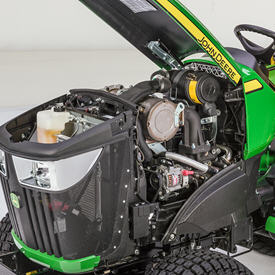
3025E
The 1.642-L (100.2 cu in.) displacement, liquid-cooled 3TNV88F-EPJT1 Yanmar® diesel engine provides 18. kW (24.4 hp) to the 3025E.
Model |
Number of |
Engine |
Rated rpm |
Gross engine hp* |
Gross engine ps* |
PTO hp |
3025E |
3 |
1.642 L (100.2 cu in.) |
2400 |
18.2 kW (24.4 hp) |
24.7 |
14.4 kW (19.4 hp) |
*Engine kW (hp), gross SAE J1995: 18.2 (24.4) at 2400 rpm, PS
Displacement, L (cu in.): 1.642 (100.2)
3032E
The 1.642-L (100.2 cu in.) displacement, liquid-cooled 3TNV88C-NJT Yanmar diesel engine provides 22.9 kW (30.7 hp) to the 3032E.
Model |
Number of |
Engine |
Rated rpm |
Gross engine hp* |
Gross engine ps* |
PTO hp |
3032E |
3 |
1.642 L (100.2 cu in.) |
2500 |
22.9 kW (30.7 hp) |
31.2 |
18.6 kW (25 hp) |
*Engine kW (hp), gross SAE J1995: 22.9 (30.7) at 2500 rpm, PS
Displacement, L (cu in): 1.642 (100.2)
3038E
The 1.568-L (95.68 cu in.) displacement, turbocharged, liquid-cooled 3TNV86T-NJT Yanmar diesel engine provides 27.4 kW (36.7 hp) to the 3038E.
Model |
Number of |
Engine |
Rated rpm |
Gross engine hp* |
Gross engine ps* |
PTO hp |
3038E |
3 |
1.568 L (95.68 cu in.) |
2500 |
27.4 kW (36.7 hp) |
37.3 |
22.4 kW (30 hp) |
*Engine kW (hp), gross SAE J1995: 27.4 (36.7) at 2500 rpm, PS
Displacement, L (cu in.): 1.568 (95.68)
The engine uses the latest technologies to optimize fuel economy, improve control and accuracy, and reduce environmental impact. The common rail system (CRS) optimizes fuel economy and reduces operating costs*. High-pressure injection atomizes fuel into finer particles which burn more completely. It results in improved fuel economy and a lower cost of operation.
The electronic control unit (ECU) provides optimum fuel control and accuracy. ECU monitors and controls the engine. It continuously monitors engine conditions and adjusts the fuel delivery accordingly to ensure optimum performance and emissions.
The engine comes with an after-treatment system. The system operates automatically. The exhaust filter consists of a diesel particulate filter (DPF) which captures particulate matter (PM) contained in the exhaust gas. Using a natural cleaning process, most of the PM trapped in the exhaust filter is eliminated by the heat of the exhaust stream generated by normal use. In situations of low temperature, engine speed, or load factor, an active cleaning cycle is initiated. In this cleaning cycle, the exhaust gas temperature is raised by injecting additional fuel during the exhaust stroke of normal vehicle operation to the diesel oxidation catalyst (DOC).
After many hours of use, the exhaust filter may require an ash removal service.
*NOTE: As compared to engines not using CRS technology.
DPF cleaning
Depending on the load that the tractor is under, as well as ambient temperature, humidity, and engine speed, the DPF may build up with particulate matter, thus requiring cleaning. Filter cleaning is determined by one of three factors:
- A prescribed time-based estimation of needed filter cleaning
- DOC/DPF pressure sensors
- A particulate matter buildup estimation based on load conditions
Once one of the three conditions has been met, filter cleaning will occur.
There are three different types of filter cleaning processes:
- Passive filter cleaning
- Active filter cleaning
- Parked filter cleaning
Passive filter cleaning
Passive filter cleaning occurs naturally when the engine is generating enough heat to oxidize particulate matter. This automatic process occurs continuously during normal operating conditions. No tractor icons or symbols appear on the display during passive filter cleaning.
NOTE: Passive filter cleaning requires no operator involvement, and there is no interruption to tractor operation.
Active filter cleaning
If conditions (temperature, load, or speed) for passive filter cleaning cannot be achieved, then PM is removed using active filter cleaner.
To achieve the required conditions, exhaust temperature management (ETM) manages the initiation and duration of active filter cleaning. ETM can adjust numerous engine parameters and/or inject a small quantity of fuel into the exhaust stream for a short duration. The fuel turns to vapor and chemically reacts with the catalysts in the DOC to create heat to oxidize the PM.
It is important to note that at no time is the fuel in the DOC/DPF ignited, and there is no flame within the DOC/DPF.
Like passive filter cleaning, active filter cleaning requires no operator involvement, and there is no interruption to tractor operation.
Parked filter cleaning
In some instances where passive and active filter cleaning have not fully cleaned the PM from the system, a parked filter cleaning may need to take place. In general, the only time a parked filter cleaning will need to occur is when automatic filter cleaning has been disabled for an extended period of time and multiple warnings to engage filter cleaning were ignored or if the tractor has been used during light load conditions. Additionally, when the automatic filter cleaning process has been deliberately interrupted multiple times, or if active filter cleaning has failed numerous times due to a failed component, a parked filter cleaning may be requested. In these rare instances the operator will have to park the tractor and start the filter cleaning process.
The parked filter cleaning process needs to be activated based on usage and operation of the tractor. The process will take approximately 30 minutes. See the operator's manual for more details.
This system constantly monitors the soot level of the tractor; making sure the tractor is always in peak performance condition. This ensures high performance at all times.
NOTE: Number of hours since last regeneration and soot level percentage are viewable on LCD display.
Key features of the engine are:
- Economical cast-in-block cylinder design for good cooling and long life
- Direct fuel injection
- Improves starting
- Injects fuel directly on top of pistons for more efficient combustion
- Develops more horsepower per liter (gallon) of fuel than indirect injection engines
- Aluminum alloy pistons are lightweight to reduce connecting rod bearing loads and provide good heat transfer characteristics
- Design permits tighter tolerances and neutralizes expansion of the piston, which reduces blow-by and noise from piston slap
- Top rings are higher on the piston and a thinner head gasket is used to greatly reduce the volume of unburned waste gases and increase combustion efficiency
- Timing gears and injector drive gears have a helical profile to reduce engine noise
- Auto-bleed fuel system
- There is no need to prime the system if the tractor runs out of fuel
- The system will self-prime the injection pump, lines, and injectors, providing fast fuel recovery for easier starting
- High-capacity lubrication system provides filtered oil, under pressure, to all engine bearings for long life
- Key start and shutoff eliminates fuel shutoff knob
- Electric solenoid shuts fuel supply off immediately when key is turned off, which replaces the need to pull a fuel shutoff lever like many older tractors
- Fuel filter with replaceable element
- Water separator with additional replaceable filter element
- See-through coolant recovery tank permits operator to check coolant level without removing radiator cap
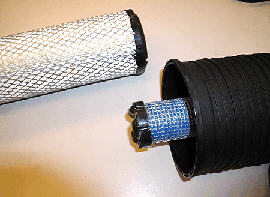 Dry-type air cleaner
Dry-type air cleaner

- Dry-type air cleaner with safety element
- Dual element design for added engine protection
- Easy to service
- Hood can be easily opened without tools for full access to the engine
- Easy access to engine check and fill points on the right-hand side of the tractor by removing the side panels.
Yanmar is a trademark of Yanmar Company Limited.
Easy-to-use hydrostatic transmission (HST) increases tractor performance
The 3E Tractors are available with a two-range hydrostatic transmission (HST) incorporated in a die-cast aluminum transmission case. Fluid under pressure transmits engine power to the drive wheels via a closed-loop pump and motor arrangement. Infinite ground speeds allow the operator to match the speed of the tractor to the job.
- No clutching for fast and easy direction changes
- Twin Touch™ foot pedals for quick and easy forward/reverse operation
- Transmission oil cooler cools transmission oil for longer transmission life
Safety features of the HST include:
-
The tractor will only start with the range lever in neutral
-
The engine will shut off if the operator leaves the seat unless the range lever is in neutral
-
The engine will shut off if the operator leaves the seat and the power take-off (PTO) is engaged
Twin Touch™ foot controls
 Twin Touch foot controls
Twin Touch foot controls
Key John Deere advantage - John Deere's Twin Touch foot controls offer several key advantages over competitive HST models tractors.
-
Some competitive hydrostatic tractors use a treadle pedal (toe-heel) design foot control for operation of the HST
-
Requires the operator to use both toe and heel to change direction, resulting in increased operator fatigue
-
The Twin Touch configuration also makes it easier to "inch" the tractor forward or rearward (i.e. when attaching to implements)
-
Optional cruise control
 Optional cruise control
Optional cruise control
The 3E Series Tractors can be outfitted with an optional cruise control switch that is installed on the right-hand control console. This gives operators the ability to keep a constant speed when in transportation, field mowing, or other applications where extended use of the transmission is needed. This kit is very quick and easy to install for those who desire this feature.
Integrated hydrostatic pump and motor
- Sauer-Danfoss® company provides the integrated pump and motor; this assures that the components are matched to each other, providing maximum efficiency
- Reduces powertrain shock loads
- Provides strength and durability needed for operating such attachments as loaders
- One reservoir (with one check point and fill point) for the transmission, differential, and hydraulic system speeds up daily maintenance
- Mechanically actuated by Twin Touch foot pedals allow selecting both directions of travel and speed with the touch of a toe
Transmission reservoir fluid checkpoint
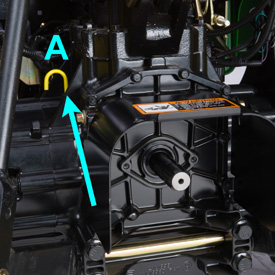 Transmission reservoir fluid checkpoint (A)
Transmission reservoir fluid checkpoint (A)

- Easy-to-reach transmission fluid dipstick allows for frequent checks of the transmission fluid level
Transmission fill point
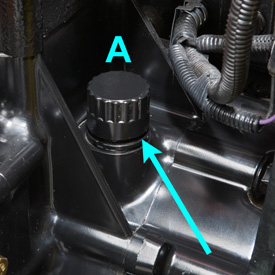 Transmission fill point
Transmission fill point

-
Easy-to-reach transmission fill point (A) located on top of rear axles on the right-hand side.
Integrated brake and differential lock pedal
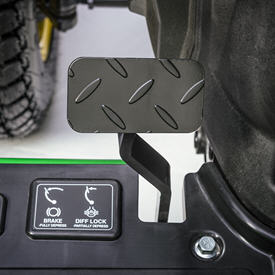 Integrated brake and differential lock pedal
Integrated brake and differential lock pedal
-
Foot-actuated differential lock is integrated into the brake pedal to simplify operator controls; the differential lock is included as base equipment to assist traction in tough spots
-
Press the brake pedal down half way to engage the differential lock that locks the rear axle for improved traction in tough spots
Sauer-Danfoss is a trademark of Sauer-Danfoss Incorporated.
Clean and simple operator station is comfortable and convenient
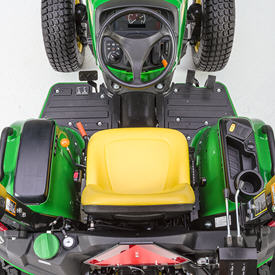 Clean and simple operator's station
Clean and simple operator's station
An uncluttered design gives operators of all sizes plenty of room to be comfortable. Color-coded controls are located on either side of the operator.
-
Hydrostatic transmission (HST) and brake pedals are designed and located for maximum comfort and ease of use.
-
Contoured, comfortable seat enhances operator comfort.
-
Seat position adjusts fore and aft
-
Seat flips forward for protection from the elements.
-
-
Flat operator platform provides for easy entry to/exit from the tractor.
-
Folding Roll-Gard™ rollover protective structure (ROPS) and retractable seat belt increase operator safety.
Operator presence system:
-
If the operator leaves the seat when the tractor is in gear, the engine shuts down
-
If the operator leaves the seat when the power take-off (PTO) is engaged, the engine shuts down
Left-side step
 Left-side step for easy entry/exit
Left-side step for easy entry/exit

-
The left-side step allows for easy access on and off the tractor.
-
Foot platform has a non-skid surface for sure footing.
Seat

The thick, soft padding on this seat provides a smooth and comfortable ride.
- Seat flips forward for protection from the elements.
- Adjustable using the fore and aft lever located under the seat, the seat slides on ramped rails to provide comfortable access to all controls.
Instrumentation
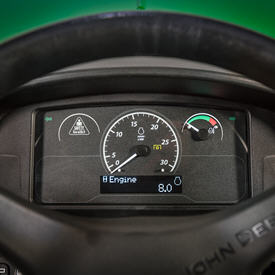 Instrument panel
Instrument panel
Easy-to-read instrument panel includes the following:
- Tachometer
- Low oil pressure indicator light
- Battery discharge indicator light
- PTO engagement indicator light
- Signal/hazard lamp indicator lights
- Multi-function liquid crystal display (LCD) display (hours, filter cleaning information, etc.)
- Filter cleaning status indicator light
Fuel gauge
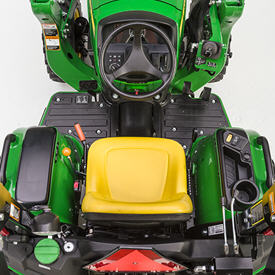 Fuel gauge
Fuel gauge
All 3E Series Tractors come standard with a fuel gauge that is easy to read from the operator's station, to ensure operators do not run out of fuel.
Safety
Operator presence switch (OPS) in seat:
-
OPS requires the operator to be in the seat to operate the transmission or PTO.
-
ROPS is designed to meet or exceed American Society of Agricultural and Biological Engineers (ASABE) safety standards.
-
Reflective ROPS strips for better tractor visibility.
-
Seat belts are in base equipment on all John Deere compact utility tractors.
-
Key switch interlock prevents bypass starting.
-
Visual PTO warning light on the instrument panel alerts the operator when the PTO is running.
-
Turn signal and flashing warning lights operate according to ASABE standards.
-
Slow-moving vehicle (SMV) sign is provided for road transport.
Park brake
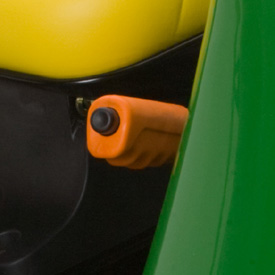 Park brake
Park brake

-
Automotive hand-style park brake for easy on/off.
-
Instrument panel has an indicator light for the park brake.
2-post Roll-Gard ROPS
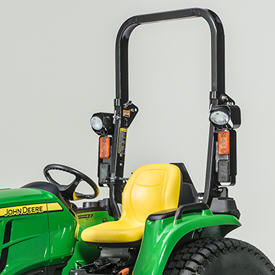 Roll-Gard ROPS
Roll-Gard ROPS
3E Series Tractors are equipped with Roll-Gard ROPS. These folding ROPS meet the ASABE standards for compact utility tractors.
- Overall height is 244.3 cm (96.2 in.) with R3 tires, 242.1 cm (95.3 in.) with R4 tires, 244.6 cm (96.3 in.) with larger R4 tires, and 244.9 cm (96.4 in.) with R1 tires. With the Roll-Gard ROPS folded down, producers can easily to get their tractor into a garage with a standard 2.1-m (7-ft) garage door.
NOTE: The use of seat belts is recommended at all times when operating the 3E Series Tractor with folding ROPS.
An optional canopy is available to help protect the operator from the elements.
Optional two-spool rear selective control valve (SCV) for superior implement performance
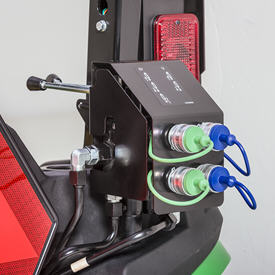
3E Series Tractors can be equipped with a field-installed rear hydraulic remote kit, providing two additional hydraulic spools on the back of the tractor. This kit can be field installed on a tractor with a loader or without a loader.
The functions are completely separate from the loader. These rear remotes can be hooked up to a wide variety of implements and attachments such as follows:
- Hydraulically angled blade
- Hydraulically controlled chute/spout on a 3-point hitch-mounted snow blower
- Hydraulic scarifiers on a box blade
- Many other hydraulic rear attachments
This versatile kit gives 3E Series Tractor operators the options they desire for putting their tractors into a wide range of tasks.
The first spool is equipped with a float position, giving the operator the ability to contour the landscape and improve the final grade with certain implements.
NOTE: Neither of the spools in this kit are equipped with a detent position; therefore, they should not be hooked up to anything with a motor, as the valve was not designed to be run open. The kit is designed for momentary, on-demand hydraulic flow such as moving a cylinder.
The approximate installation time is 1 hour to 1.5 hours.
Optional iMatch™ Quick-Hitch feature allows for easy implement hookup
 iMatch Quick-Hitch
iMatch Quick-Hitch
 iMatch Quick-Hitch with rotary cutter hookup
iMatch Quick-Hitch with rotary cutter hookup
 iMatch Quick-Hitch (LVB25976)
iMatch Quick-Hitch (LVB25976)
 iMatch Quick-Hitch with rotary cutter hookup (LVB25976)
iMatch Quick-Hitch with rotary cutter hookup (LVB25976)
One of the greatest operator concerns involves difficulty in attaching tractor implements. John Deere has addressed this issue with the iMatch Quick-Hitch.
The iMatch Quick-Hitch provides easy hookup and a guaranteed fit for all Category 1 implements that are designed to meet the American Society of Agricultural and Biological Engineers (ASABE) Category 1 Standard S278.6 for quick-attach hitches.
- All implements require a set of bushings in order for the attachment to fit and work properly with the iMatch Quick-Hitch. One set of bushings comes with the iMatch Quick-Hitch.
NOTE: The bushing set can be seen in the picture above. These bushings allow the hooks on the iMatch and the pins on the implement to fit together properly. All other implements (box blades, tillers, rear blades, etc.) will require a set of bushings to enlarge the pin to fit with the iMatch hooks. Bushings of different lengths can be found in the parts system or through a bushing supplier (see dimensions below).
- Upper bushing
- Inside diameter: 1.93-1.95 cm (0.76-0.77 in.)
- Outside diameter: 3.15-3.18 cm (1.24-1.25 in.)
- Lower bushings
- Inside diameter: 2.24-2.26 cm (0.88 to 0.89 in.)
- Outside diameter: 3.63-3.66 cm (1.43 to 1.44 in.)
Excellent serviceability reduces operational costs and improves productivity
Regular service and maintenance are essential to the performance, productivity, and longevity of the tractor.
- Easy access to most regular service points minimizes service time
- Four quarter turn fasteners allow operators to easily remove the engine side panels without tools to access the engine compartment

- Tractors are equipped with extensive onboard self-diagnostic capabilities and are fully compatible with the John Deere-exclusive Service ADVISOR™ system
- Hydraulic oil service interval increased to 1200 hours when using Hy-Gard™ products
- Hydraulic oil filter will need to be changed every 400 hours
- Fuel tank is located on the rear of the tractor to allow for easy access when fueling

- Gas-lift hood support eliminates the need for a mechanical prop rod.

- Daily service requirements are minimal and simple to accomplish. Most service interval requirements can be performed with a basic understanding of procedures and common tools
 Removable side panels (previous model shown)
Removable side panels (previous model shown)
All items in the daily service schedule can be performed without the use of tools:
- Engine oil, hydraulic oil, coolant level, and the water separator can be conveniently accessed
- The engine can be easily accessed by simply raising the hood for more periodic maintenance checks
NOTE: Always refer to the operator’s manual for complete maintenance and service recommendations.
Features
Powerful, high-torque diesel engine delivers superb efficiency
 Yanmar 3-cylinder, TNV series diesel engine
Yanmar 3-cylinder, TNV series diesel engine
2032R
The 1.642 L displacement, liquid-cooled 3TNV88C-NJT Yanmar® diesel engine provides 31.2 hp to the 2032R.
Model |
Number of cylinders |
Engine displacement |
Aspiration |
Gross engine hp* |
Gross engine ps* |
PTO hp* |
2032R |
3 |
100 cu. in. (1.642L) |
Natural |
30.7 |
31.2 |
24.2 |
*Engine hp (kW), gross SAE J1995: 31.2 (23) @ 2500 rpm, PS
Displacement, in.3 (L): 100.2 (1.642)
2038R
The 1.568L displacement, turbocharged liquid-cooled 3TNV86T-NJT Yanmar® diesel engine provides 37.3 hp to the 2038R.
Model |
Number of cylinders |
Engine displacement |
Aspiration |
Gross engine hp* |
Gross engine ps* |
PTO hp* |
2038R |
3 |
95.8 cu. in. (1.568L) |
Turbocharged |
36.8 |
37.3 |
30.4 |
*Engine hp (kW), gross SAE J1995: 37.3 (27.4) @ 2500 rpm, PS
Displacement, in.3 (L): 95.8 (1.568L)
The engine uses the latest technologies to optimize fuel economy, improve control and accuracy, and reduce environmental impact.
The common rail system (CRS) optimizes fuel economy and reduces operating costs*. High-pressure injection atomizes fuel into finer particles which burn more completely. It results in improved fuel economy and a lower cost of operation.
The electronic control unit (ECU) provides optimum fuel control and accuracy. ECU monitors and controls the engine. It continuously monitors engine conditions and adjusts the fuel delivery accordingly to ensure optimum performance and emissions.
The engine comes with an after-treatment system. The system operates automatically. The exhaust filter consists of a diesel particulate filter (DPF) which captures particulate matter (PM) contained in the exhaust gas. Using a natural cleaning process, most of the PM trapped in the exhaust filter is eliminated by the heat of the exhaust stream generated by normal use. In situations of low temperature, engine speed or load factor, an active cleaning cycle is initiated. In this cleaning cycle, the exhaust gas temperature is raised by injecting additional fuel during the exhaust stroke of normal vehicle operation to the diesel oxidation catalyst (DOC).
After many hours of use, the exhaust filter may require an ash removal service.
Diesel Oxidation Catalyst (DOC)/Diesel Particulate Filter (DPF)

Depending on the load that the tractor is under, as well as ambient temperature, humidity, and engine speed, the DPF may build up with particulate matter, thus requiring cleaning. Filter cleaning is determined by one of three conditions:
- A prescribed time-based estimation of needed filter cleaning
- DOC/DPF pressure sensors
- A particulate matter buildup estimation based on load conditions
Once one of the three conditions has been met, filter cleaning will occur.
There are three different types of filter cleaning processes:
- Passive filter cleaning
- Active filter cleaning
- Parked filter cleaning
Passive filter cleaning
Passive filter cleaning occurs naturally when the engine is generating enough heat to oxidize particulate matter. This automatic process occurs continuously during normal operating conditions. No tractor icons or symbols appear on the display during passive filter cleaning.
NOTE: Passive filter cleaning requires no operator involvement, and there is no interruption to tractor operation.
Active filter cleaning
If conditions (temperature, load, or speed) for passive filter cleaning cannot be achieved, then particulate matter is removed using active filter cleaner.
To achieve the required conditions, exhaust temperature management (ETM) manages the initiation and duration of active filter cleaning. ETM can adjust numerous engine parameters and/or inject a small quantity of fuel into the exhaust stream for a short duration. The fuel turns to vapor and chemically reacts with the catalysts in the DOC to create heat to oxidize particulate matter.
It is important to note that at no time is fuel in the DOC/DPF ignited, and there is no interruption to tractor operation.
Like passive filter cleaning, active filter cleaning requires no operator involvement, and there is no interruption to tractor operation.
Parked filter cleaning
In some instances where passive and active filter cleaning have not fully cleaned the particulate matter from the system, a parked filter cleaning may need to take place. Most likely, the only time a parked filter cleaning will need to occur is when automatic filter cleaning has been disabled for an extended period of time and multiple warnings to engage filter cleaning were ignored or if the tractor has been used during light load conditions. Additionally, when the automatic filter cleaning process has been deliberately interrupted multiple times, or if active filter cleaning has failed numerous times due to a failed component, a parked filter cleaning may be requested. In these rare instances the operator will have to park the tractor and start the filter cleaning process.
The parked filter cleaning process needs to be activated based on usage and operation of the tractor. The process will take approximately 30 minutes. See operator’s manual for more details.
The emissions system on this engine constantly monitors the soot level of the tractor, making sure the tractor is always in peak performance condition. This ensures high performance at all times.
NOTE: Number of hours since last regeneration and soot level percentage viewable on LCD display.
For more information regarding EPA regulations and the technology behind John Deere Integrated Emissions Control systems, please visit the following link:
http://www.deere.com/wps/dcom/en_US/campaigns/ag_turf/emissions/final_tier_4.page
Yanmar TNV Series engine offers these features:
- Economical cast-in-block cylinder design for good cooling and long life
- Direct fuel injection
- Improves starting
- Injects fuel directly on top of pistons for more efficient combustion
- Develops more horsepower per gallon of fuel than indirect injection engines
- Aluminum alloy pistons are lightweight to reduce connecting rod bearing loads and provide good heat transfer characteristics
- Design permits tighter tolerances and neutralizes expansion of the piston, which reduces blow-by and noise from piston slap
- Top rings are higher on the piston and a thinner head gasket is used to greatly reduce the volume of unburned waste gases and increase combustion efficiency
- Timing gears and injector drive gears have a helical profile to reduce engine noise
- Auto-bleed fuel system
- There is no need to prime the system if the tractor runs out of fuel
- The system will self-prime the injection pump, lines and injectors, providing fast fuel recovery for easier starting
- High-capacity lubrication system provides filtered oil, under pressure, to all engine bearings for long life
- Fuel filter with replaceable element
- Water separator with additional replaceable filter element
- See-through coolant recovery tank permits operator to check coolant level without removing radiator cap
- Dry-type air cleaner with safety element
- Dual element design for added engine protection
- Air cleaner service indicator is standard equipment on all models and alerts the operator on the instrument panels
- Easy access to engine check and fill points on the right-hand side of the tractor by removing the side panels
Easy-to-use hydrostatic transmission (HST) increases productivity
The 2032R and 2038R Tractors are equipped with a two-range hydrostatic transmission (HST) incorporated in a die-cast aluminum transmission case. Fluid under pressure transmits engine power to the drive wheels via a closed-loop pump and motor arrangement. Infinite ground speeds allow the operator to match the speed of the tractor to the job.
- No clutching for fast and easy direction changes
- Twin Touch™ foot pedals for quick and easy forward/reverse operation
- Transmission oil cooler cools transmission oil for longer transmission life
Safety features of the HST transmission include:
- The tractor will only start with the range lever in neutral
- If the range lever is in gear when the key is turned to the start position, the instrument panel instructs the operator to shift to neutral
- The engine will shut off if the operator leaves the seat and the power take-off (PTO) is engaged
Twin Touch foot controls
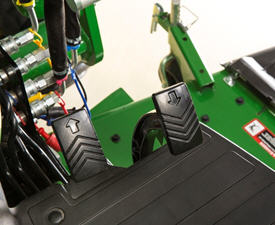 Twin Touch foot controls
Twin Touch foot controls
Key John Deere advantages – John Deere’s Twin Touch foot controls offer several key advantages over competitive HST models tractors.
- Some competitive hydrostatic tractors use a treadle pedal (toe-heel) design foot control for operation of the HST
- Requires the operator to use both toe and heel to change direction, resulting in increased operator fatigue
- The Twin Touch configuration also makes it easier to inch the tractor forward or rearward (i.e., when attaching to implements)
Integrated hydrostatic pump and motor
- Sauer-Danfoss® manufacturer provides the integrated pump and motor; this assures that the components are matched to each other, providing maximum efficiency
- Provides strength and durability needed for operating such attachments as loaders and backhoes
- One reservoir (with one check-point and fill point) for the transmission, differential, and hydraulic system speeds up daily maintenance
- Mechanically actuated by Twin Touch foot pedals allow the operator to select both directions of travel and speed with the touch of a toe
Cruise control
An electronic cruise control is standard equipment on the 2032R and 2038R Tractors. Cruise control is electronically engaged and disengaged using a toggle switch located on the right-hand console.
- Maintains desired forward speed without having to touch the forward pedal
- To disengage the cruise control, either apply pressure to the brake pedal or disengage the cruise control switch
Sauer-Danfoss is a trademark of Sauer-Danfoss Incorporated.
Operator station is comfortable and convenient
 Operator Station
Operator Station
The operator station has been designed to allow for greater operator comfort and increased visibility. The ergonomic layout and convenient color coded controls allow for easy identification and operation. The design of the operator station allows operators to sit “in” as opposed to “on” which provides comfort and increased stability.
Below are other key features of the 2032R and 2038R Tractor operator’s station:
- Sloping hood design provides improved visibility
- Plenty of room for comfortable operation
- Cup holder, multiple storage compartments and a 12V outlet ensures an organized operator station
- Rubberized floor mat design to reduce vibration and noise
- Step-through operator platform makes getting on and off the tractor easy
- Fender-mounted handrails, large and easy to grab, assist the operator when getting on and off the tractor
- Controls have been raised and integrated into the fender for operator comfort and ease of use
- Large, easy to read decals provide clear instructions for experienced and even non experienced operators
- Front horizontal exhaust for increased operator visibility
- If the operator leaves the tractor seat when the transmission, mid PTO, or rear PTO is engaged, the engine will shut down
- For applications where out-of-seat PTO operation is required, the following criteria must be met: transmission in neutral, park brake engaged, and PTO selector set to rear only. See operator's manual for specific instructions.
- Specially designed panels route hot air flow from the engine compartment under the tractor instead of directly onto the operator
Left-side step
 Left-side entrance step
Left-side entrance step
- The left-side step allows for easy access on and off the tractor
- Foot platform has a non-skid surface
Premium seat
 Premium high-back seat
Premium high-back seat
The thick, soft padding on this seat provides a smooth and comfortable ride. A high, scalloped back makes it easier for the operator to turn to view rear implements.
- Seat adjusts fore/aft for operator convenience
- Seat flips forward for protection from the elements
- High seat back and armrests are in base equipment and allow for a more comfortable operation
- Retractable seat belt feature prevent the seat belt from becoming tangled in the seat suspension and controls
Key features of the operator’s station include:
- Tilt steering wheel design in base equipment on the 2032R and 2038R Tractors
- Allows the operator to adjust the steering wheel to the most comfortable position
- Provides additional clearance for the operator to enter and exit the tractor
- Provides easy return to the fully raised position
- Provides plenty of room for comfortable operation
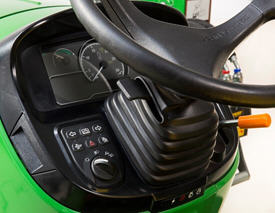 Tilt steering lever
Tilt steering lever
- Easy-fold ROPS allows tractor to be used or stored in low clearance environments
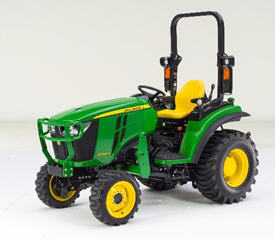
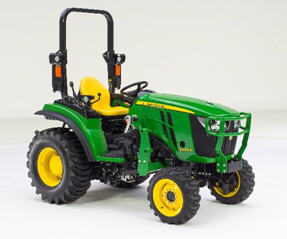
Optional iMatch™ Quick-Hitch feature allows for easy implement hookup
 iMatch Quick-Hitch
iMatch Quick-Hitch
 iMatch Quick-Hitch with rotary cutter hookup
iMatch Quick-Hitch with rotary cutter hookup
 iMatch Quick-Hitch (LVB25976)
iMatch Quick-Hitch (LVB25976)
 iMatch Quick-Hitch with rotary cutter hookup (LVB25976)
iMatch Quick-Hitch with rotary cutter hookup (LVB25976)
One of the greatest operator concerns involves difficulty in attaching tractor implements. John Deere has addressed this issue with the iMatch Quick-Hitch.
The iMatch Quick-Hitch provides easy hookup and a guaranteed fit for all Category 1 implements that are designed to meet the American Society of Agricultural and Biological Engineers (ASABE) Category 1 Standard S278.6 for quick-attach hitches.
- All implements require a set of bushings in order for the attachment to fit and work properly with the iMatch Quick-Hitch. One set of bushings comes with the iMatch Quick-Hitch.
NOTE: The bushing set can be seen in the picture above. These bushings allow the hooks on the iMatch and the pins on the implement to fit together properly. All other implements (box blades, tillers, rear blades, etc.) will require a set of bushings to enlarge the pin to fit with the iMatch hooks. Bushings of different lengths can be found in the parts system or through a bushing supplier (see dimensions below).
- Upper bushing
- Inside diameter: 1.93-1.95 cm (0.76-0.77 in.)
- Outside diameter: 3.15-3.18 cm (1.24-1.25 in.)
- Lower bushings
- Inside diameter: 2.24-2.26 cm (0.88 to 0.89 in.)
- Outside diameter: 3.63-3.66 cm (1.43 to 1.44 in.)
CommandCut™ controls allows quick and accurate height of cut adjustments
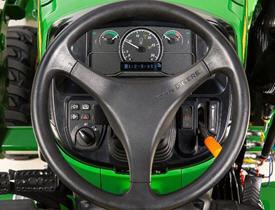 New designed instrument panel
New designed instrument panel
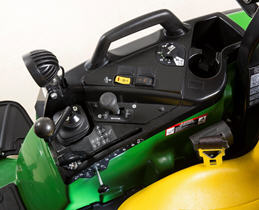 CommandCut™ controls
CommandCut™ controls
The 2032R and 2038R tractors feature a newly designed, CommandCut™ mower deck lift system, which allows quick and accurate adjustments of the mower deck with the turn of a dial and the bump of a lever. Control callouts make operation simple and repeatable. The height of cut setting dial and raise/lower lever are conveniently located on the right-hand console and easily accessible by the operator. Some of the key benefits of this system are:
- Installing CommandCut™ only requires a simple calibration after installation. It is a true “plug-and-play” system as no controller programming is required.
- Inhibits PTO operation when mower deck is in the install position to prevent PTO driveling and mower deck blade damage
- Eliminates the need for hydraulic power and components, thus dedicating all hydraulic capacity to other implements or tract functions
- Fewer hydraulic components means fewer hydraulic leaks, especially when working on sensitive turf
- Precise height of cut with no drift or leakdown
- System can be calibrated to different tire sizes to maintain precision
- Minimum effort required to set height of cut and to raise/lower the mower deck which reduces operator fatigue
- Easy to read graphical interface on the instrument panel allows operator to glance at the desired height of cut while staying focused on mowing
- Built in transport lock can be activated from the seat by turning the height of cut dial to position 6 and raising the deck to the highest position
Excellent serviceability and diagnostics reduce operational cost and improves productivity
Regular service and maintenance are essential to the performance, productivity, and longevity of the tractor.
- Tractors are equipped with extensive onboard self-diagnostic capabilities and are fully compatible with the John Deere-exclusive ServiceADVISOR™ system.

- Four quarter turn fasteners allow operators to easily remove the engine side panels without tools to access to the engine compartment.
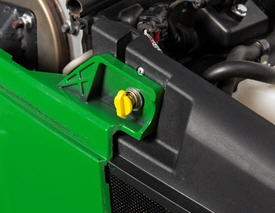 Quarter turn fasteners
Quarter turn fasteners
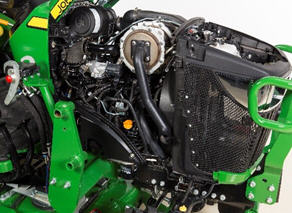 Right tractor side panel removed
Right tractor side panel removed
- Easy access to regular service points minimizes service time
- Daily service checks, such as checking the engine oil or water separator, can be done without opening the hood or removing the tractor side panels
- Tractors are equipped with an electronic air filter restriction indicator that alerts the operator when the air filter needs to be cleaned or changed
 Air filter restriction sensor
Air filter restriction sensor
- Daily service requirements are minimal and simple to accomplish. Most service interval requirements can be performed with a basic understanding of procedures and common tools.
- All external engine, fuel and transmission filters are easily accessible
- Increased service intervals lessen overall cost of ownership
- Hydraulic oil service interval increased to 1200 hours when using Hy-Gard™ products
- Hydraulic oil filter will need to be changed every 400 hours
- Fuel tank is located on the rear of the tractor to allow for easy access when fueling
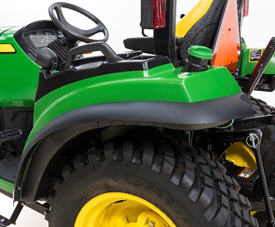 Fuel Tank
Fuel Tank
- Gas-lift hood support eliminates the need for a mechanical prop rod
 Gas-lift hood shocks
Gas-lift hood shocks
All items in the daily service schedule can be performed without the use of tools:
- Engine oil, hydraulic oil, coolant level, and the water separator can be conveniently accessed
- The engine can be easily accessed by simply raising the hood for more periodic maintenance checks
NOTE: Always refer to the operator’s manual for complete maintenance and service recommendations.
Increase productivity with standard eThrottle feature
 eThrottle switch
eThrottle switch
The 2032R and 2038R Tractors come equipped with the eThrottle feature. This feature is designed to make the tractor quieter and use less fuel. With eThrottle engaged, the engine rpm and transmission speed will increase as the Twin Touch™ pedals are depressed. This feature can be beneficial for use in many different applications, especially for front loader work and when transporting on roads or in parking lots.
To enable the system, producers press the switch located on the right side of the front console. Once the system is enabled, engine speed will then increase or decrease in unison as the Twin Touch transmission pedals are depressed.
For loader work, producers will get maximum benefit from the system by increasing engine rpm with the hand throttle to at least 50 percent. Once the hand throttle is set, eThrottle will help provide the feeling of a power boost when the producer is filling the bucket with material from a pile. The harder the Twin Touch pedal is pressed, the more engine speed available. In this scenario, as the producer presses the pedal, the engine will operate between 50 percent throttle and 100 percent throttle. It will not go below 50 percent until the hand throttle is lowered back down.
For transport applications, it is recommended to engage eThrottle but leave the hand throttle set to low idle so that eThrottle can control the entire range of engine speed from 0 percent up to 100 percent.
In power take-off (PTO) applications such as mowing or snow blowing, eThrottle is not recommended because PTO implements usually require a constant speed in order to properly function.
Features
Powerful, high-torque diesel engine delivers superb efficiency
 Yanmar 3-cylinder, TNV series diesel engine
Yanmar 3-cylinder, TNV series diesel engine
2032R
The 1.642 L displacement, liquid-cooled 3TNV88C-NJT Yanmar® diesel engine provides 31.2 hp to the 2032R.
Model |
Number of cylinders |
Engine displacement |
Aspiration |
Gross engine hp* |
Gross engine ps* |
PTO hp* |
2032R |
3 |
100 cu. in. (1.642L) |
Natural |
30.7 |
31.2 |
24.2 |
*Engine hp (kW), gross SAE J1995: 31.2 (23) @ 2500 rpm, PS
Displacement, in.3 (L): 100.2 (1.642)
2038R
The 1.568L displacement, turbocharged liquid-cooled 3TNV86T-NJT Yanmar® diesel engine provides 37.3 hp to the 2038R.
Model |
Number of cylinders |
Engine displacement |
Aspiration |
Gross engine hp* |
Gross engine ps* |
PTO hp* |
2038R |
3 |
95.8 cu. in. (1.568L) |
Turbocharged |
36.8 |
37.3 |
30.4 |
*Engine hp (kW), gross SAE J1995: 37.3 (27.4) @ 2500 rpm, PS
Displacement, in.3 (L): 95.8 (1.568L)
The engine uses the latest technologies to optimize fuel economy, improve control and accuracy, and reduce environmental impact.
The common rail system (CRS) optimizes fuel economy and reduces operating costs*. High-pressure injection atomizes fuel into finer particles which burn more completely. It results in improved fuel economy and a lower cost of operation.
The electronic control unit (ECU) provides optimum fuel control and accuracy. ECU monitors and controls the engine. It continuously monitors engine conditions and adjusts the fuel delivery accordingly to ensure optimum performance and emissions.
The engine comes with an after-treatment system. The system operates automatically. The exhaust filter consists of a diesel particulate filter (DPF) which captures particulate matter (PM) contained in the exhaust gas. Using a natural cleaning process, most of the PM trapped in the exhaust filter is eliminated by the heat of the exhaust stream generated by normal use. In situations of low temperature, engine speed or load factor, an active cleaning cycle is initiated. In this cleaning cycle, the exhaust gas temperature is raised by injecting additional fuel during the exhaust stroke of normal vehicle operation to the diesel oxidation catalyst (DOC).
After many hours of use, the exhaust filter may require an ash removal service.
Diesel Oxidation Catalyst (DOC)/Diesel Particulate Filter (DPF)

Depending on the load that the tractor is under, as well as ambient temperature, humidity, and engine speed, the DPF may build up with particulate matter, thus requiring cleaning. Filter cleaning is determined by one of three conditions:
- A prescribed time-based estimation of needed filter cleaning
- DOC/DPF pressure sensors
- A particulate matter buildup estimation based on load conditions
Once one of the three conditions has been met, filter cleaning will occur.
There are three different types of filter cleaning processes:
- Passive filter cleaning
- Active filter cleaning
- Parked filter cleaning
Passive filter cleaning
Passive filter cleaning occurs naturally when the engine is generating enough heat to oxidize particulate matter. This automatic process occurs continuously during normal operating conditions. No tractor icons or symbols appear on the display during passive filter cleaning.
NOTE: Passive filter cleaning requires no operator involvement, and there is no interruption to tractor operation.
Active filter cleaning
If conditions (temperature, load, or speed) for passive filter cleaning cannot be achieved, then particulate matter is removed using active filter cleaner.
To achieve the required conditions, exhaust temperature management (ETM) manages the initiation and duration of active filter cleaning. ETM can adjust numerous engine parameters and/or inject a small quantity of fuel into the exhaust stream for a short duration. The fuel turns to vapor and chemically reacts with the catalysts in the DOC to create heat to oxidize particulate matter.
It is important to note that at no time is fuel in the DOC/DPF ignited, and there is no interruption to tractor operation.
Like passive filter cleaning, active filter cleaning requires no operator involvement, and there is no interruption to tractor operation.
Parked filter cleaning
In some instances where passive and active filter cleaning have not fully cleaned the particulate matter from the system, a parked filter cleaning may need to take place. Most likely, the only time a parked filter cleaning will need to occur is when automatic filter cleaning has been disabled for an extended period of time and multiple warnings to engage filter cleaning were ignored or if the tractor has been used during light load conditions. Additionally, when the automatic filter cleaning process has been deliberately interrupted multiple times, or if active filter cleaning has failed numerous times due to a failed component, a parked filter cleaning may be requested. In these rare instances the operator will have to park the tractor and start the filter cleaning process.
The parked filter cleaning process needs to be activated based on usage and operation of the tractor. The process will take approximately 30 minutes. See operator’s manual for more details.
The emissions system on this engine constantly monitors the soot level of the tractor, making sure the tractor is always in peak performance condition. This ensures high performance at all times.
NOTE: Number of hours since last regeneration and soot level percentage viewable on LCD display.
For more information regarding EPA regulations and the technology behind John Deere Integrated Emissions Control systems, please visit the following link:
http://www.deere.com/wps/dcom/en_US/campaigns/ag_turf/emissions/final_tier_4.page
Yanmar TNV Series engine offers these features:
- Economical cast-in-block cylinder design for good cooling and long life
- Direct fuel injection
- Improves starting
- Injects fuel directly on top of pistons for more efficient combustion
- Develops more horsepower per gallon of fuel than indirect injection engines
- Aluminum alloy pistons are lightweight to reduce connecting rod bearing loads and provide good heat transfer characteristics
- Design permits tighter tolerances and neutralizes expansion of the piston, which reduces blow-by and noise from piston slap
- Top rings are higher on the piston and a thinner head gasket is used to greatly reduce the volume of unburned waste gases and increase combustion efficiency
- Timing gears and injector drive gears have a helical profile to reduce engine noise
- Auto-bleed fuel system
- There is no need to prime the system if the tractor runs out of fuel
- The system will self-prime the injection pump, lines and injectors, providing fast fuel recovery for easier starting
- High-capacity lubrication system provides filtered oil, under pressure, to all engine bearings for long life
- Fuel filter with replaceable element
- Water separator with additional replaceable filter element
- See-through coolant recovery tank permits operator to check coolant level without removing radiator cap
- Dry-type air cleaner with safety element
- Dual element design for added engine protection
- Air cleaner service indicator is standard equipment on all models and alerts the operator on the instrument panels
- Easy access to engine check and fill points on the right-hand side of the tractor by removing the side panels
Easy-to-use hydrostatic transmission (HST) increases productivity
The 2032R and 2038R Tractors are equipped with a two-range hydrostatic transmission (HST) incorporated in a die-cast aluminum transmission case. Fluid under pressure transmits engine power to the drive wheels via a closed-loop pump and motor arrangement. Infinite ground speeds allow the operator to match the speed of the tractor to the job.
- No clutching for fast and easy direction changes
- Twin Touch™ foot pedals for quick and easy forward/reverse operation
- Transmission oil cooler cools transmission oil for longer transmission life
Safety features of the HST transmission include:
- The tractor will only start with the range lever in neutral
- If the range lever is in gear when the key is turned to the start position, the instrument panel instructs the operator to shift to neutral
- The engine will shut off if the operator leaves the seat and the power take-off (PTO) is engaged
Twin Touch foot controls
 Twin Touch foot controls
Twin Touch foot controls
Key John Deere advantages – John Deere’s Twin Touch foot controls offer several key advantages over competitive HST models tractors.
- Some competitive hydrostatic tractors use a treadle pedal (toe-heel) design foot control for operation of the HST
- Requires the operator to use both toe and heel to change direction, resulting in increased operator fatigue
- The Twin Touch configuration also makes it easier to inch the tractor forward or rearward (i.e., when attaching to implements)
Integrated hydrostatic pump and motor
- Sauer-Danfoss® manufacturer provides the integrated pump and motor; this assures that the components are matched to each other, providing maximum efficiency
- Provides strength and durability needed for operating such attachments as loaders and backhoes
- One reservoir (with one check-point and fill point) for the transmission, differential, and hydraulic system speeds up daily maintenance
- Mechanically actuated by Twin Touch foot pedals allow the operator to select both directions of travel and speed with the touch of a toe
Cruise control
An electronic cruise control is standard equipment on the 2032R and 2038R Tractors. Cruise control is electronically engaged and disengaged using a toggle switch located on the right-hand console.
- Maintains desired forward speed without having to touch the forward pedal
- To disengage the cruise control, either apply pressure to the brake pedal or disengage the cruise control switch
Sauer-Danfoss is a trademark of Sauer-Danfoss Incorporated.
Operator station is comfortable and convenient
 Operator Station
Operator Station
The operator station has been designed to allow for greater operator comfort and increased visibility. The ergonomic layout and convenient color coded controls allow for easy identification and operation. The design of the operator station allows operators to sit “in” as opposed to “on” which provides comfort and increased stability.
Below are other key features of the 2032R and 2038R Tractor operator’s station:
- Sloping hood design provides improved visibility
- Plenty of room for comfortable operation
- Cup holder, multiple storage compartments and a 12V outlet ensures an organized operator station
- Rubberized floor mat design to reduce vibration and noise
- Step-through operator platform makes getting on and off the tractor easy
- Fender-mounted handrails, large and easy to grab, assist the operator when getting on and off the tractor
- Controls have been raised and integrated into the fender for operator comfort and ease of use
- Large, easy to read decals provide clear instructions for experienced and even non experienced operators
- Front horizontal exhaust for increased operator visibility
- If the operator leaves the tractor seat when the transmission, mid PTO, or rear PTO is engaged, the engine will shut down
- For applications where out-of-seat PTO operation is required, the following criteria must be met: transmission in neutral, park brake engaged, and PTO selector set to rear only. See operator's manual for specific instructions.
- Specially designed panels route hot air flow from the engine compartment under the tractor instead of directly onto the operator
Left-side step
 Left-side entrance step
Left-side entrance step
- The left-side step allows for easy access on and off the tractor
- Foot platform has a non-skid surface
Premium seat
 Premium high-back seat
Premium high-back seat
The thick, soft padding on this seat provides a smooth and comfortable ride. A high, scalloped back makes it easier for the operator to turn to view rear implements.
- Seat adjusts fore/aft for operator convenience
- Seat flips forward for protection from the elements
- High seat back and armrests are in base equipment and allow for a more comfortable operation
- Retractable seat belt feature prevent the seat belt from becoming tangled in the seat suspension and controls
Key features of the operator’s station include:
- Tilt steering wheel design in base equipment on the 2032R and 2038R Tractors
- Allows the operator to adjust the steering wheel to the most comfortable position
- Provides additional clearance for the operator to enter and exit the tractor
- Provides easy return to the fully raised position
- Provides plenty of room for comfortable operation
 Tilt steering lever
Tilt steering lever
- Easy-fold ROPS allows tractor to be used or stored in low clearance environments


Optional iMatch™ Quick-Hitch feature allows for easy implement hookup
 iMatch Quick-Hitch
iMatch Quick-Hitch
 iMatch Quick-Hitch with rotary cutter hookup
iMatch Quick-Hitch with rotary cutter hookup
 iMatch Quick-Hitch (LVB25976)
iMatch Quick-Hitch (LVB25976)
 iMatch Quick-Hitch with rotary cutter hookup (LVB25976)
iMatch Quick-Hitch with rotary cutter hookup (LVB25976)
One of the greatest operator concerns involves difficulty in attaching tractor implements. John Deere has addressed this issue with the iMatch Quick-Hitch.
The iMatch Quick-Hitch provides easy hookup and a guaranteed fit for all Category 1 implements that are designed to meet the American Society of Agricultural and Biological Engineers (ASABE) Category 1 Standard S278.6 for quick-attach hitches.
- All implements require a set of bushings in order for the attachment to fit and work properly with the iMatch Quick-Hitch. One set of bushings comes with the iMatch Quick-Hitch.
NOTE: The bushing set can be seen in the picture above. These bushings allow the hooks on the iMatch and the pins on the implement to fit together properly. All other implements (box blades, tillers, rear blades, etc.) will require a set of bushings to enlarge the pin to fit with the iMatch hooks. Bushings of different lengths can be found in the parts system or through a bushing supplier (see dimensions below).
- Upper bushing
- Inside diameter: 1.93-1.95 cm (0.76-0.77 in.)
- Outside diameter: 3.15-3.18 cm (1.24-1.25 in.)
- Lower bushings
- Inside diameter: 2.24-2.26 cm (0.88 to 0.89 in.)
- Outside diameter: 3.63-3.66 cm (1.43 to 1.44 in.)
CommandCut™ controls allows quick and accurate height of cut adjustments
 New designed instrument panel
New designed instrument panel
 CommandCut™ controls
CommandCut™ controls
The 2032R and 2038R tractors feature a newly designed, CommandCut™ mower deck lift system, which allows quick and accurate adjustments of the mower deck with the turn of a dial and the bump of a lever. Control callouts make operation simple and repeatable. The height of cut setting dial and raise/lower lever are conveniently located on the right-hand console and easily accessible by the operator. Some of the key benefits of this system are:
- Installing CommandCut™ only requires a simple calibration after installation. It is a true “plug-and-play” system as no controller programming is required.
- Inhibits PTO operation when mower deck is in the install position to prevent PTO driveling and mower deck blade damage
- Eliminates the need for hydraulic power and components, thus dedicating all hydraulic capacity to other implements or tract functions
- Fewer hydraulic components means fewer hydraulic leaks, especially when working on sensitive turf
- Precise height of cut with no drift or leakdown
- System can be calibrated to different tire sizes to maintain precision
- Minimum effort required to set height of cut and to raise/lower the mower deck which reduces operator fatigue
- Easy to read graphical interface on the instrument panel allows operator to glance at the desired height of cut while staying focused on mowing
- Built in transport lock can be activated from the seat by turning the height of cut dial to position 6 and raising the deck to the highest position
Excellent serviceability and diagnostics reduce operational cost and improves productivity
Regular service and maintenance are essential to the performance, productivity, and longevity of the tractor.
- Tractors are equipped with extensive onboard self-diagnostic capabilities and are fully compatible with the John Deere-exclusive ServiceADVISOR™ system.

- Four quarter turn fasteners allow operators to easily remove the engine side panels without tools to access to the engine compartment.
 Quarter turn fasteners
Quarter turn fasteners
 Right tractor side panel removed
Right tractor side panel removed
- Easy access to regular service points minimizes service time
- Daily service checks, such as checking the engine oil or water separator, can be done without opening the hood or removing the tractor side panels
- Tractors are equipped with an electronic air filter restriction indicator that alerts the operator when the air filter needs to be cleaned or changed
 Air filter restriction sensor
Air filter restriction sensor
- Daily service requirements are minimal and simple to accomplish. Most service interval requirements can be performed with a basic understanding of procedures and common tools.
- All external engine, fuel and transmission filters are easily accessible
- Increased service intervals lessen overall cost of ownership
- Hydraulic oil service interval increased to 1200 hours when using Hy-Gard™ products
- Hydraulic oil filter will need to be changed every 400 hours
- Fuel tank is located on the rear of the tractor to allow for easy access when fueling
 Fuel Tank
Fuel Tank
- Gas-lift hood support eliminates the need for a mechanical prop rod
 Gas-lift hood shocks
Gas-lift hood shocks
All items in the daily service schedule can be performed without the use of tools:
- Engine oil, hydraulic oil, coolant level, and the water separator can be conveniently accessed
- The engine can be easily accessed by simply raising the hood for more periodic maintenance checks
NOTE: Always refer to the operator’s manual for complete maintenance and service recommendations.
Increase productivity with standard eThrottle feature
 eThrottle switch
eThrottle switch
The 2032R and 2038R Tractors come equipped with the eThrottle feature. This feature is designed to make the tractor quieter and use less fuel. With eThrottle engaged, the engine rpm and transmission speed will increase as the Twin Touch™ pedals are depressed. This feature can be beneficial for use in many different applications, especially for front loader work and when transporting on roads or in parking lots.
To enable the system, producers press the switch located on the right side of the front console. Once the system is enabled, engine speed will then increase or decrease in unison as the Twin Touch transmission pedals are depressed.
For loader work, producers will get maximum benefit from the system by increasing engine rpm with the hand throttle to at least 50 percent. Once the hand throttle is set, eThrottle will help provide the feeling of a power boost when the producer is filling the bucket with material from a pile. The harder the Twin Touch pedal is pressed, the more engine speed available. In this scenario, as the producer presses the pedal, the engine will operate between 50 percent throttle and 100 percent throttle. It will not go below 50 percent until the hand throttle is lowered back down.
For transport applications, it is recommended to engage eThrottle but leave the hand throttle set to low idle so that eThrottle can control the entire range of engine speed from 0 percent up to 100 percent.
In power take-off (PTO) applications such as mowing or snow blowing, eThrottle is not recommended because PTO implements usually require a constant speed in order to properly function.
Features
Durable, efficient, high-torque 3-cylinder diesel engine provides adequate power
 3-cylinder Yanmar TNV Series diesel engine
3-cylinder Yanmar TNV Series diesel engine
Power is provided by a durable and efficient high-torque three-cylinder Yanmar® TNV Series diesel engine.
This series of engines was developed to meet Tier 4 Environmental Protection Agency (EPA) environmental requirements by featuring low levels of both exhaust and emissions.
Model |
Number of |
Engine |
Gross engine power |
Power take-off (PTO) power |
2025R |
3 |
1.267 L |
18 kW (24.2 hp) |
13.4 kW (18.0 hp) |
Yanmar TNV Series engine offers these features:
- Economical for good cooling and long life
- Isolated engine provides reduced vibration and noise for the operator; indirect fuel injection uses a precombustion chamber to give the engine a smooth and quiet operation; aluminum-alloy piston with built-in steel struts are lightweight to reduce connection rod bearing loads and provide good heat transfer characteristics
- Design permits tighter tolerances and neutralizes expansion of the piston, thereby reducing blow-by gas and less noise from the piston slap
- Higher top rings on the piston and a thinner head gasket greatly reduces the volume of unburned waste gases and increases combustion efficiency
- Timing-gear teeth have a designed roll-off profile giving almost no clash,nonoise,andnobacklash
- High-torque reserve provides plenty of power under heavy load, yet retains excellent fuel economy
- Easy access to engine check and fill points on the right-hand side of the tractor by removing the side panels
- Fuel filter with replaceable element
- Full-pressure lubrication system provides filtered oil under pressure to all vital engine parts
- Glow plugs provide quick starts in temperatures down to -18°C (0°F) (Optional engine coolant heater attachment will assist starting under more extreme conditions.)
- Auto-bleed fuel system means there is no special bleeding required if the tractor runs out of fuel; this system will self-prime the injection pump, lines, and injectors, providing fast fuel recovery
- Key start and shut off eliminates fuel shut-off knob
- Electric solenoid shuts fuel supply off immediately when key is turned off
- See-through coolant recovery tank permits operator to check coolant level without removing radiator cap
- Dry-type air cleaner with safety element keeps dirt and other contaminants out of the engine
- Safety element (second filter) will protect engine if primary filter would develop a leak
- Protects engine when servicing primary filter
- Air filter restriction indicator is standard equipment on the 2025R Tractor
- Sealed-radiator compartment keeps trash and debris on outside of hood
- Horizontal exhaust discharges fumes away from the operator station, reducing noise and improving operator visibility and comfort
Yanmar is a trademark of Yanmar Company Limited.
Easy-to-use hydrostatic transmission (HST) increases efficiency
The 2R Series are equipped with a two-range hydrostatic transmission (HST) incorporated in a die-cast aluminum transmission case. Fluid under pressure transmits engine power to the drive wheels via a closed-loop pump and motor arrangement. Infinite ground speeds allow the operator to match the speed of the tractor to the job.
- No clutching for fast and easy direction changes
- Twin Touch™ foot pedals for quick and easy forward/reverse operation
- Transmission oil cooler cools transmission oil for longer transmission life
Safety features of the HST include:
- The tractor will only start with the range lever in neutral
- If the range lever is in gear when the key is turned to the start position, the instrument panel instructs the operator to shift to neutral
- The engine will shut off if the operator leaves the seat and the forward/reverse pedals are depressed
 Twin Touch foot controls
Twin Touch foot controls
Two-range transmission
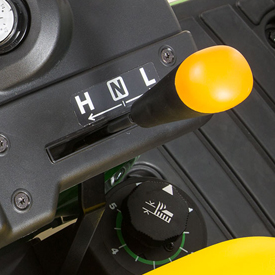 Two-speed transmission
Two-speed transmission

Transmission has two speeds - hi and lo range.
- The range lever is located next to the seat, conveniently within reach of the operator
- All tasks can be performed using two ranges on the 2025R which means less shifting throughout the day
Durability features include:
- Large forged one-piece trunnion shaft with larger support bearings that reduce vibration and noise
- Innovative transaxle combines an HST, gear reduction axle, and clutch
- Pressure side filtration allows the use of a fine-mesh filter
- One pump to supply charge pressure and implement A flow divider splits the flow to various circuits throughout the tractor.
- The transaxle has an oil cooler which provides improved hydraulic cooling performance
Fast and easy implement changeover offers versatility
 Easy to change implements
Easy to change implements

- Front Quik-Tatch™ hitch makes changing front implements quick and easy
- All front implements (blades, brooms, and snow blowers) use a common hitch
- AutoConnect™ Mid-Mount Mower Deck, 120R Loader, and 260B Backhoe can be taken on or off within 5 minutes, and no tools are required
- Changing rear implements is a snap with the iMatch™ Quick-Hitch, which has three fixed points to back in and pick up a rear implement that is iMatch compatible
Implement compounding improves efficiency
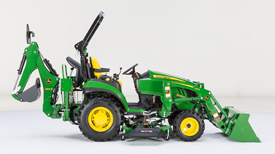 Implement compounding (2025R Tractor shown)
Implement compounding (2025R Tractor shown)
- Loader, mid-mower, and a variety of rear hitch implements can be attached to the tractor at the same time
Optional premium independent mid lift system operates independent of the rear 3-point hitch. This gives the operator the flexibility to leave the mid mower attached when completing other tasks.
Open operator's station is comfortable and convenient
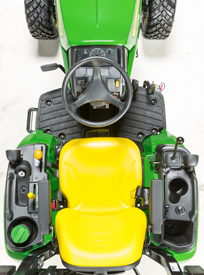 Open operator's station
Open operator's station

The operator’s station has been designed to allow for greater operator comfort and increased visibility. The ergonomic layout and convenient color-coded controls with large labels allow for easy identification and operation. Large and easy to grab handrails are located on each fender for an easier on and off of the tractor from either side.
Below are other key features of the 2025R Tractor operator’s station:
- Sloping hood design provides improved visibility
- Plenty of room for comfortable operation
- Cup holder, multiple storage compartments, and a 12-V outlet ensures an organized operator’s station
- Fender-mounted handrails are large and easy to grab, assist the operator in getting on and off the tractor
- Rubberized floor mat design to reduce vibration and noise
- Step-through operator platform makes getting on and off the tractor easy
- Front-horizontal exhaust for increased operator visibility
- Controls have been raised and integrated into the fender for operator comfort and ease of use
- Large, easy-to-read decals provide clear instructions for experienced and even non-experienced operators
- Portable toolbox integrated into the front frame of the tractor
- Fuel tank is located on the rear of the tractor to allow for easy access when fueling
Left-side step
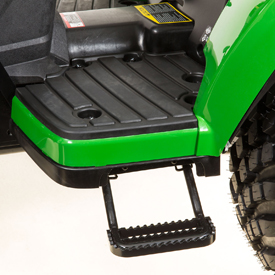 Left-side step
Left-side step
- The left-side step allows for easy access on and off the tractor
- Foot platform has non-skid surface
Premium seat
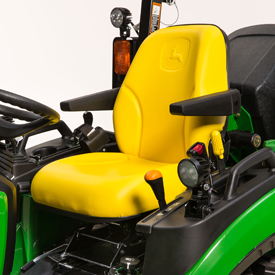 Premium seat
Premium seat
The thick, soft padding on this seat provides a smooth and comfortable ride. A high, scalloped back makes it easier for the operator to turn to view rear implements. The embroidered logo and premium vinyl not only provide an easy-to-clean surface but also a well-polished design.
- Seat adjusts fore/aft for operator convenience
- Seat flips forward for protection from the elements
- High seat back and armrests are in base equipment and allow for a more comfortable operation
- Retractable seat belt feature prevents the seat belt from becoming tangled in the seat suspension and controls
Key features of the operator’s station include:
- Tilt steering wheel design in base equipment on the 2025R Tractor
- Allows the operator to adjust the steering wheel to the most comfortable position
- Provides additional clearance for the operator to enter and exit the tractor
- Provides easy return to the fully raised position
- Provides plenty of room for comfortable operation
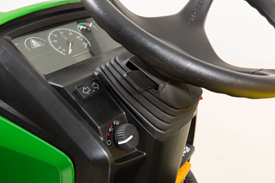 Tilt steering wheel design
Tilt steering wheel design
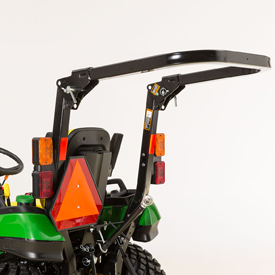 Folding rollover protective structure
Folding rollover protective structure
- Easy-fold rollover protective structure (ROPS) allows the tractor to be used or stored in low-clearance environments
Lighting
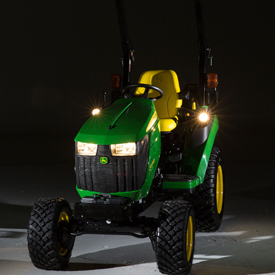 Standard lighting shown
Standard lighting shown
 Optional premium lighting shown
Optional premium lighting shown
Standard equipment lighting includes:
-
Two front-mounted sealed-beam halogen headlights
-
Two amber-flashing warning/hazard lights mounted on the side of the ROPS with reflectors
-
Two additional fender lights are standard on the 2025R
- Additional front- and rear-light kits are available
For those operators requiring additional lighting, additional light options are available:
- Premium light kit
- Two light-emitting diode (LED) fender lights
- Two LED ROPS work lights (adjustable 360 degrees for forward or rear lighting)
- One LED rear PTO light
- Auxiliary rear work light
- One halogen light
- Forward halogen work light kit
- Contains two ROPS mounted lights
- Forward LED work light kit
- Contains two ROPS mounted lights
NOTE: Lights mounted to the ROPS will require the warning light brush guard kit.
Optional work light brush guards can be ordered to protect lights from debris.
Premium independent mower lift system allows quick and easy adjustment

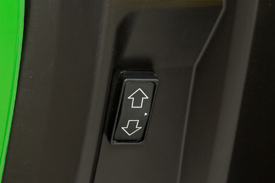
The optional premium independent lift system has been improved over the current 1 Family system by now allowing the operator to have full control of the mower deck in both the raise and lower positions. When the operator reaches the desired height, the button can be released and the deck will hold its position. This feature reduces the effort required to adjust the height-of-cut (HOC) dial and it also allows for quick height changes on the go.
Optional iMatch™ Quick-Hitch feature allows for easy implement hookup
 iMatch Quick-Hitch
iMatch Quick-Hitch
 iMatch Quick-Hitch with rotary cutter hookup
iMatch Quick-Hitch with rotary cutter hookup
 iMatch Quick-Hitch (LVB25976)
iMatch Quick-Hitch (LVB25976)
 iMatch Quick-Hitch with rotary cutter hookup (LVB25976)
iMatch Quick-Hitch with rotary cutter hookup (LVB25976)
One of the greatest operator concerns involves difficulty in attaching tractor implements. John Deere has addressed this issue with the iMatch Quick-Hitch.
The iMatch Quick-Hitch provides easy hookup and a guaranteed fit for all Category 1 implements that are designed to meet the American Society of Agricultural and Biological Engineers (ASABE) Category 1 Standard S278.6 for quick-attach hitches.
- All implements require a set of bushings in order for the attachment to fit and work properly with the iMatch Quick-Hitch. One set of bushings comes with the iMatch Quick-Hitch.
NOTE: The bushing set can be seen in the picture above. These bushings allow the hooks on the iMatch and the pins on the implement to fit together properly. All other implements (box blades, tillers, rear blades, etc.) will require a set of bushings to enlarge the pin to fit with the iMatch hooks. Bushings of different lengths can be found in the parts system or through a bushing supplier (see dimensions below).
- Upper bushing
- Inside diameter: 1.93-1.95 cm (0.76-0.77 in.)
- Outside diameter: 3.15-3.18 cm (1.24-1.25 in.)
- Lower bushings
- Inside diameter: 2.24-2.26 cm (0.88 to 0.89 in.)
- Outside diameter: 3.63-3.66 cm (1.43 to 1.44 in.)
Superb serviceability improves productivity
Regular service and maintenance are essential to the performance, productivity, and longevity of the tractor.
- Two quarter-turn fasteners allow operators to easily remove the engine side panels without tools to access to the engine compartment.
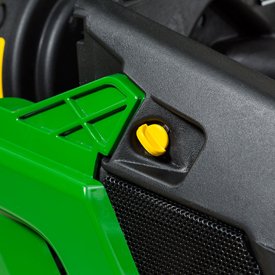 Fasteners on the engine side panels
Fasteners on the engine side panels
- The under-hood gas-lift support provides easy access to the engine compartment and eliminates the need for a mechanical prop rod.
 Under-hood gas lift makes it easy to access the engine
Under-hood gas lift makes it easy to access the engine
External hood latch requires no tools and can release using the tractor key.
Easy access to regular service points minimizes service time.
Daily service checks, such as checking the engine oil or water separator, can be done without opening the hood or removing the tractor side panels.
Tractors are equipped with a mechanical air filter restriction indicator that alerts the operator when the air filter needs to be cleaned or changed.
 Air filter restriction indicator
Air filter restriction indicator
- All external engine, fuel, and transmission filters are easily accessible.
- Fuel tank is located on the rear of the tractor to allow for easy access when fueling.
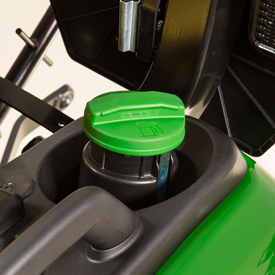 Fuel tank at rear of tractor
Fuel tank at rear of tractor
NOTE: Always refer to the operator’s manual for complete maintenance and service recommendations.
Factory-installed mechanical mower deck lift components reduces dealer initial mower deck install
 2025R Tractor
2025R Tractor
- The 2025R model includes factory-installed mechanical deck lift components.
- The addition of these components from the factory significantly reduces the time required to do the initial mower deck installation at the time of purchase.
- Refer to the mowers and material collection page for more details on mower deck installation and compatibility.
Increase productivity with optional auto throttle feature
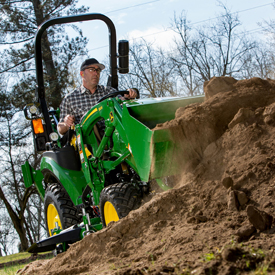 Increased productivity using auto throttle
Increased productivity using auto throttle
An optional auto throttle kit is available for the 2025R Tractors. When auto throttle is installed, the engine rpm and transmission speed will increase as the Twin Touch™ pedals are depressed. The harder the hydro pedal is pressed, the more engine speed available. This feature can be beneficial for use in many different applications, especially for front loader work and when transporting on roads or in parking lots. It is designed to make the tractor quieter and use less fuel.
For loader work, producers will get maximum benefit from the system by increasing engine rpm with the hand throttle to at least 50 percent. Once the hand throttle is set, auto throttle will help provide the feeling of a power boost when the producer is filling the bucket with material from a pile. In this scenario, as the operator presses the pedal, the engine will operate between 50 percent throttle and 100 percent throttle. It will not go below 50 percent until the hand throttle is lowered back down.
In power take-off (PTO) applications such as mowing or snow blowing, auto throttle is not recommended because PTO implements usually require a constant speed in order to properly function and optimize performance.
Optional cab offers protection from elements
The Mauser cab offers protection from the elements and expands the versatility of 2025R Tractors to perform in all climates.
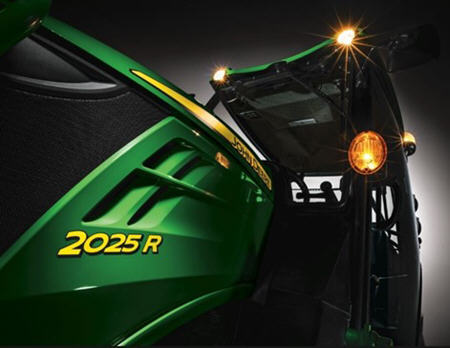 2025R cab
2025R cab
Key features:
- Full glass doors for maximum visibility
- Curved glass for a styled look
- Sealed for cold weather operation
- Easily removable for summer operation
- Heater with fan
- Switches and vents integrated into headliner
- Dome light
- Fully openable front and rear windows with gas struts
- Front sun visor
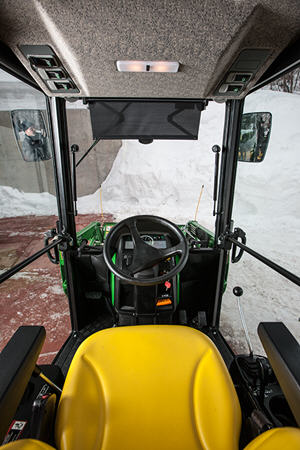 Operator view from inside the cab
Operator view from inside the cab
- Front work lights
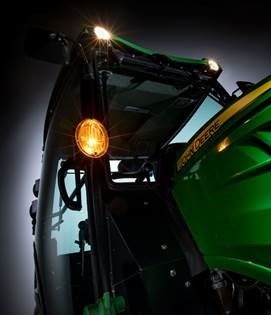 Front work lights
Front work lights
- Front wiper with washer system
- Dual outside mirrors
- Rollover protective structure (ROPS) certified cab frame
- Allows for improved rear visibility
- Reduces overall height
- Rubber isolation at all mounting points
- Interior sound insulation
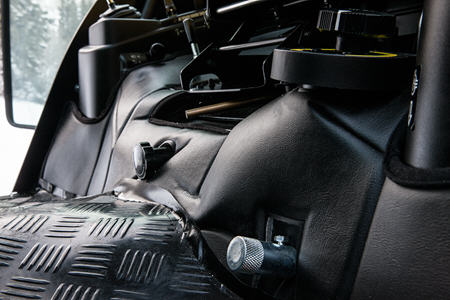 Interior sound insulation
Interior sound insulation
- Immersion-primed and powder-coated cab frame
- Provides superior corrosion resistance
- Integrated John Deere styling
 John Deere styling on 2025R cab
John Deere styling on 2025R cab
Specifications:
- Cab height: 1495 mm (58.9 in.)
- Overall height when installed: 2040 mm (80.3 in.)
- Overall height when installed to top of beacon: 2210 mm (87 in.)
- Overall width with cab installed: same as tractor width
- Cab weight: 236 kg (520 lb)
Optional kits:
- Rear wiper kit – LP70011
- Stereo kit – LP70016
- Radio – SWJHD1130 (AM/FM, weatherband,)
- Beacon light kit – LP70012
- Light-emitting diode (LED) rear work light kit – LP70013
- Illuminated license plate kit – LP70014
Compatibility and installation:
- Compatible with:
- Model year 2017 and newer 2025R Tractors
- Not compatible with:
- 260B Backhoe
Features
Spend more time working and less time switching equipment with easy implement swaps
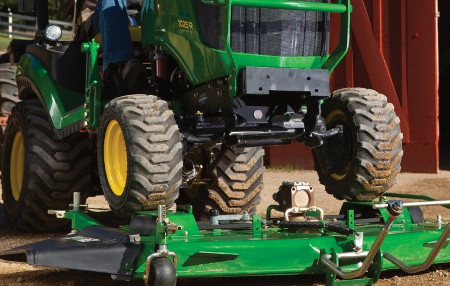 Drive-over deck makes connection simple
Drive-over deck makes connection simple
1 Family Tractors are designed to minimize the time and effort needed to switch-out implements to accommodate different jobs.
- AutoConnect Deck System: Connect a mid-mount mower deck to the tractor in less than 60 seconds without leaving the seat except to lock the gauge wheels.
- Load-N-Go attachment: Easily move your 60D Autoconnect Deck with your John Deere Loader after it has been disconnected from the tractor with the Load-N-Go ramps.
- Quik-Park™ Loader System: 120R Quik-Park™ Loaders are designed for easy mounting and removal in about a minute, with no tools needed.
- Quik-Tatch™ front hitch: Save time switching front implements like a snow blower, rotary broom, or front blade without tools.
- iMatch™ quick-hitch: Easily hookup Category 1 implements in seconds using three fixed points to back in and pick up rear implements without leaving the seat
- Position control hitch: Set the rear hitch height and then consistently lower the hitch to the exact height every time, which is especially useful in grading and leveling applications.
- Quik-Knect™ system: Connect power take-off (PTO)-driven implements quickly and with low physical effort. The Quik-Knect system utilizes one connector for the tractor’s PTO shaft and a designated connector for each implement which eliminates twisting and forcing splines to align.
1 Family Tractors can have up to three implements mounted simultaneously due to standard dual selective control valves (SCVs), allowing you to switch from using one implement to another without stopping to adjust. When a third SCV kit is added, the number of possible combinations is greatly increased.
Quickly and easily change speed and directions with Twin Touch foot controls and Hydrostatic transmission (HST)
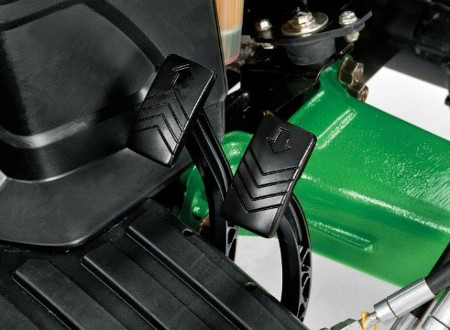 Twin Touch™ pedals
Twin Touch™ pedals
The hydrostatic transmission’s infinite ground speeds and direction of travel are both controlled with the Twin Touch foot pedals.
- Ideal for loader or mower applications where frequent direction and speed changes are needed
- No clutching for fast direction changes
- Match the job at hand with infinite ground speeds
Excellent maneuverability and easy operation with standard four-wheel drive (4WD) and power steering
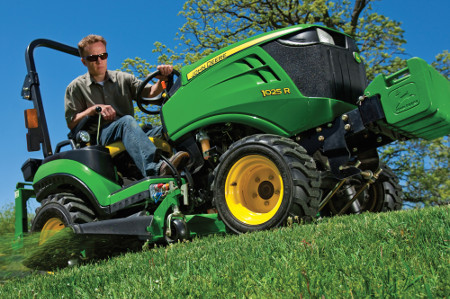 Standard 4WD and power steering make 1 Family Tractors excellent for mowing
Standard 4WD and power steering make 1 Family Tractors excellent for mowing
Both 4WD and power steering are standard equipment on the 1 Family Tractors. This combination allows for excellent maneuverability and ease of operation.
- Narrow overall width allows you to work in tight areas where most compact tractors just cannot fit. The 144.8-cm (57-in.) wheel base and 119.4 cm (47 in.) overall width gives great stability for all types of terrain.
- Power steering means fewer turns of the steering wheel than manual steering, which is especially valuable when mowing around obstacles or during front loader work.
- High horsepower-to-weight ratio makes the 1 Family Tractors a good choice for a variety of tasks. The overall tractor weight reduces ground compaction and makes them excellent for mowing.
- The fully-independent power take-off (PTO) allows engaging and disengaging of the PTO without stopping tractor movement. This is important when driving across obstacles such as driveways while mowing.
Comfortable and convenient open operator’s station
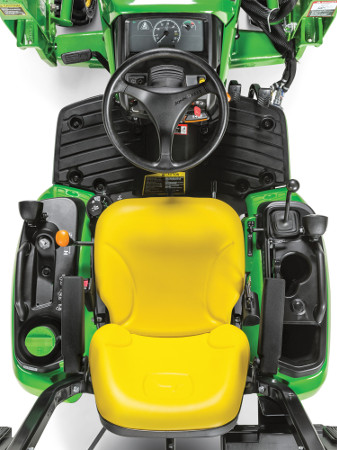 1025R open operator station
1025R open operator station
The 1025R open operator station is designed for greater comfort and increased visibility.
Comfortable operation
- Thick, textured rubber floor mat reduces vibrations and absorbs shock and noise
- Step-through flat platform and fender-mounted handrails make it easy to get on and off the tractor from either side
- Controls are conveniently located next to the fenders and are color-coded for quick identification
- Tilt steering lets you keep your arms in a natural position to reduce fatigue
- Deluxe suspension seat has moveable armrests and provides great back support
- Easy access toolbox puts common tools within quick reach
- Standard 12-volt outlet for convenient charging of electronics
- Easy-lift hood with dual gas-charged lift struts as standard equipment. A simple flip of the latch lets you open the rugged composite hood, providing wide open access to the engine compartment.
- Foldable ROPS keeps you protected during operation and improve the ability to store tractor in a garage
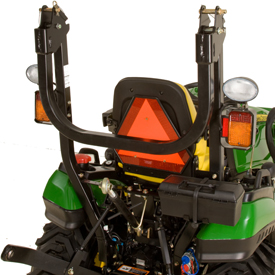 Foldable Roll-Gard ROPS
Foldable Roll-Gard ROPS
Foldable Roll-Gard™ rollover protective structure (ROPS) is standard equipment on 1025R
Increased visibility
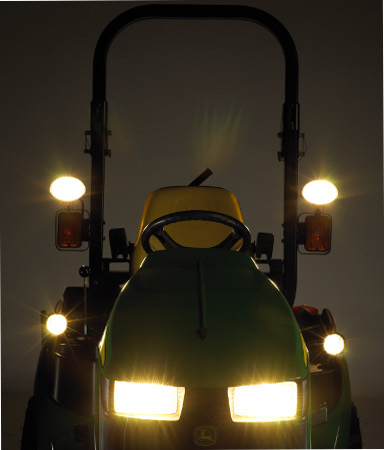 Standard (and optional) lighting shown
Standard (and optional) lighting shown
- Sloping hood design provides improved visibility especially during front loader work
- Standard lighting equipment allows you to work from early in the morning to late at night:
- Two front-mounted sealed-beam halogen headlights
- Two amber-flashing warning/hazard lights mounted on the side of the ROPS with reflectors
- Two additional fender lights are standard on the 1025R
- Additional front- and rear-light kits are available
Get year-round performance with the optional cab
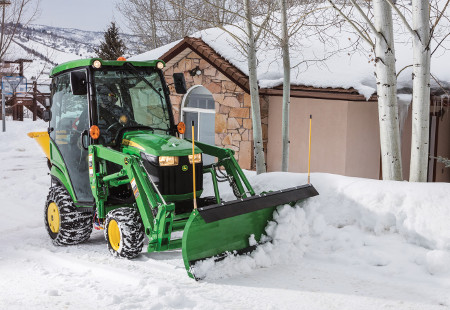 Heated cab is ideal for cold weather chores
Heated cab is ideal for cold weather chores
The John Deere 1R cab is about comfort, security, and helping you get year-round performance. The cab offers protection from the elements to expand the versatility of 1025R Tractors to perform in all climates.
- Sound damping system for quiet, peace-of-mind operation
- Heated cab keeps you warm in colder months
- Removable doors and front and rear windows that open nearly 90 degrees provide a cooler work environment in warmer months.
- Excellent visibility to your surroundings with the full glass doors
- Compatible with all tractor implements except the 260 Backhoe
Flexibility in operation with multiple mid-mower lift system options
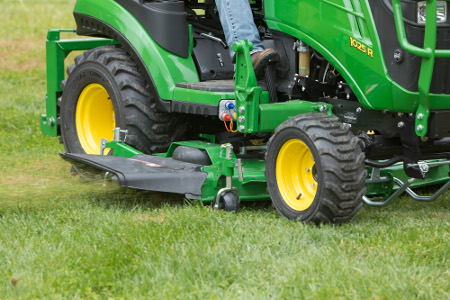 Mid-mower lift system options
Mid-mower lift system options
Mid-mower lift system options
Standard mechanical mower lift
The standard mechanical mower lift system moves the mower in conjunction with the rear implements and comes factory-installed on 1 Family Tractors.
Optional hydraulic mower lift
The optional hydraulic mower lift system allows the mower to be raised and lowered independently of the rear implements. It uses the loader joystick to lift and lower the mower deck.
Optional independent hydraulic mower lift
The optional independent hydraulic lift system allows the mower to be raised and lowered independently of the rear and front implements. It operates using a rocker switch mounted on the tractor, located at the operator’s left knee.
For more information on this mid mower lift system click here.
Features
Spend more time working and less time switching equipment with easy implement swaps
 Drive-over deck makes connection simple
Drive-over deck makes connection simple
1 Family Tractors are designed to minimize the time and effort needed to switch-out implements to accommodate different jobs.
- AutoConnect Deck System: Connect a mid-mount mower deck to the tractor in less than 60 seconds without leaving the seat except to lock the gauge wheels.
- Load-N-Go attachment: Easily move your 60D Autoconnect Deck with your John Deere Loader after it has been disconnected from the tractor with the Load-N-Go ramps.
- Quik-Park™ Loader System: 120R Quik-Park™ Loaders are designed for easy mounting and removal in about a minute, with no tools needed.
- Quik-Tatch™ front hitch: Save time switching front implements like a snow blower, rotary broom, or front blade without tools.
- iMatch™ quick-hitch: Easily hookup Category 1 implements in seconds using three fixed points to back in and pick up rear implements without leaving the seat
- Position control hitch: Set the rear hitch height and then consistently lower the hitch to the exact height every time, which is especially useful in grading and leveling applications.
- Quik-Knect™ system: Connect power take-off (PTO)-driven implements quickly and with low physical effort. The Quik-Knect system utilizes one connector for the tractor’s PTO shaft and a designated connector for each implement which eliminates twisting and forcing splines to align.
1 Family Tractors can have up to three implements mounted simultaneously due to standard dual selective control valves (SCVs), allowing you to switch from using one implement to another without stopping to adjust. When a third SCV kit is added, the number of possible combinations is greatly increased.
Quickly and easily change speed and directions with Twin Touch foot controls and Hydrostatic transmission (HST)
 Twin Touch™ pedals
Twin Touch™ pedals
The hydrostatic transmission’s infinite ground speeds and direction of travel are both controlled with the Twin Touch foot pedals.
- Ideal for loader or mower applications where frequent direction and speed changes are needed
- No clutching for fast direction changes
- Match the job at hand with infinite ground speeds
Excellent maneuverability and easy operation with standard four-wheel drive (4WD) and power steering
 Standard 4WD and power steering make 1 Family Tractors excellent for mowing
Standard 4WD and power steering make 1 Family Tractors excellent for mowing
Both 4WD and power steering are standard equipment on the 1 Family Tractors. This combination allows for excellent maneuverability and ease of operation.
- Narrow overall width allows you to work in tight areas where most compact tractors just cannot fit. The 144.8-cm (57-in.) wheel base and 119.4 cm (47 in.) overall width gives great stability for all types of terrain.
- Power steering means fewer turns of the steering wheel than manual steering, which is especially valuable when mowing around obstacles or during front loader work.
- High horsepower-to-weight ratio makes the 1 Family Tractors a good choice for a variety of tasks. The overall tractor weight reduces ground compaction and makes them excellent for mowing.
- The fully-independent power take-off (PTO) allows engaging and disengaging of the PTO without stopping tractor movement. This is important when driving across obstacles such as driveways while mowing.
Comfortable and convenient open operator’s station
 Open operator's station (1025R shown)
Open operator's station (1025R shown)
The 1023E open operator station is designed for greater comfort and increased visibility.
Comfortable operation
- Thick, textured rubber floor mat reduces vibrations and absorbs shock and noise
- Step-through flat platform and fender-mounted handrails make it easy to get on and off the tractor from either side
- Controls are conveniently located next to the fenders and are color-coded for quick identification
- Easy-lift hood with dual gas-charged lift struts as standard equipment. A simple flip of the latch lets you open the rugged composite hood, providing wide open access to the engine compartment.
- Foldable ROPS keeps you protected during operation and improve the ability to store tractor in a garage
 Foldable Roll-Gard ROPS
Foldable Roll-Gard ROPS
Foldable Roll-Gard™ rollover protective structure (ROPS) is standard equipment on 1023E.
Increased visibility
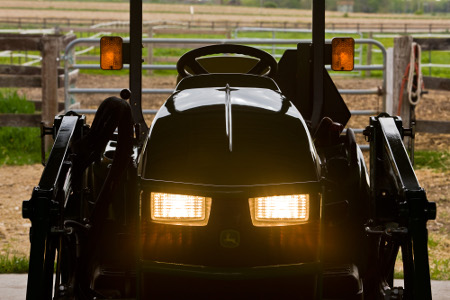 Standard (and optional) lighting shown
Standard (and optional) lighting shown
- Sloping hood design provides improved visibility especially during front loader work
- Standard lighting equipment allows you to work from early in the morning to late at night:
- Two front-mounted sealed-beam halogen headlights
- Two amber-flashing warning/hazard lights mounted on the side of the ROPS with reflectors
- Built-in tail light on one warning/hazardous light
- Additional front- and rear-light kits are available
Flexibility in operation with multiple mid-mower lift system options
 Mid-mower lift system options
Mid-mower lift system options
Mid-mower lift system options
Standard mechanical mower lift
The standard mechanical mower lift system moves the mower in conjunction with the rear implements and comes factory-installed on 1 Family Tractors.
Optional hydraulic mower lift
The optional hydraulic mower lift system allows the mower to be raised and lowered independently of the rear implements. It uses the loader joystick to lift and lower the mower deck.
Optional independent hydraulic mower lift
The optional independent hydraulic lift system allows the mower to be raised and lowered independently of the rear and front implements. It operates using a rocker switch mounted on the tractor, located at the operator’s left knee.
For more information on this mid mower lift system click here.
Features
Design includes a heavy-duty formed and welded steel frame
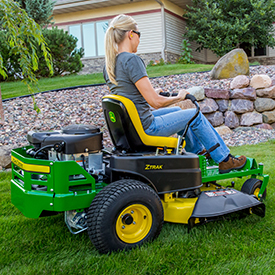 ZTrak™ Z335E shown
ZTrak™ Z335E shown
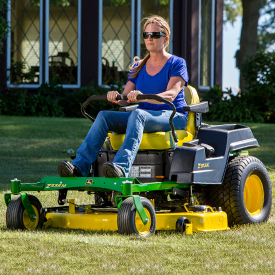 ZTrak Z535M shown
ZTrak Z535M shown
ZTrak Mowers are designed around a heavy-duty formed and welded steel frame for strength and reliability.
Large front caster wheels and large rear drive wheels provide several operator benefits:
-
Smoother ride
-
Better slope performance
-
More operator comfort over uneven ground
-
Better traction
The operator platform is roomy and uncluttered for maximum comfort, and the controls are convenient to use:
- Easy to get on and off the mower
- Ample legroom for comfortable operation
- Adjustable motion-control levers for height and position, enabling the operator to stay comfortable while using them
- Color-coded and logically placed controls
Engine is smooth and powerful V-twin design with features for reliability and long life
 24-hp (17.9-kW) engine
24-hp (17.9-kW) engine
 Overhead valve engine
Overhead valve engine
Key engine features include:
- 24 hp (17.9 kW) provides plenty of power.
- Large 44.3 cu in. (726-cc) displacement provides plenty of torque.
- V-twin air-cooled design is efficient.
- Excellent power and performance
- Smooth, quiet power
- Easy starts
- Engine model FS730V
- Many quality features are included.
- Cast-iron cylinder liners provide a long-wearing surface for longer engine life.
- Overhead valves allow the engine to breathe easily for excellent power and fuel economy.
- Full-pressure lubrication is more effective.
- Replaceable oil filter keeps the oil cleaner for longer engine life.
- Dual-stage air cleaner thoroughly cleans engine intake air.
- Electronic ignition contributes to fast starts.
- Solenoid-shift starter for easy starts, even in cold weather.
- Rear engine guard protects the engine and provides additional vehicle strength and integrity.
- A flywheel alternator provides plenty of capacity to quickly recharge the battery and power electrical equipment, such as lights or a sprayer.
- 20-amp capacity
- Regulated to keep the battery at a full charge, without risk of overcharging
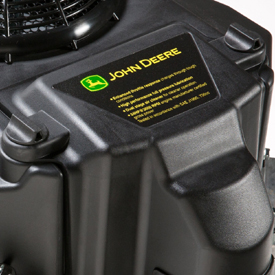 Air filter cover
Air filter cover
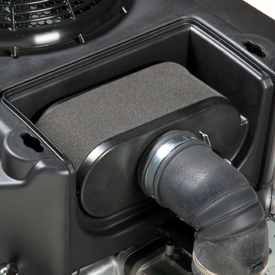 Cover removed to show air filter
Cover removed to show air filter
First-stage foam filter stops large dirt particles before they make contact with the filter.
The air filter is easily removed for cleaning or replacement.
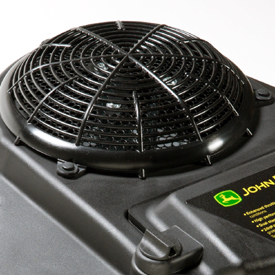 Engine cooling-air screen
Engine cooling-air screen
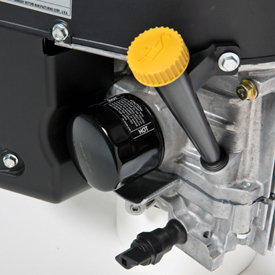 Engine oil fill, filter, and drain
Engine oil fill, filter, and drain
Air screen cover provides protection for the rotating air screen. Rotating screen filters out debris and reduces the size of material that gets through so it will pass harmlessly past the engine fins.
Full-pressure lubrication system provides plenty of oil to the engines moving parts to ensure reliable operation and long life:
-
Replaceable oil filter keeps the oil cleaner for a longer engine life.
-
Extends the time between oil changes
-
-
Full-pressure lubrication is more effective.
-
No-tools oil drain is convenient to use.
John Deere recommends the use of fuel stabilizer in gasoline. See Fuel-Protect for gasoline engines (8 oz [237 mL]) for more information.
Operator station is designed for comfort and convenience
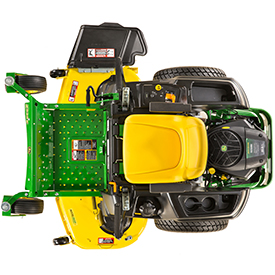 Operator station (Z535M shown)
Operator station (Z535M shown)
 Color-coded controls are easy to identify
Color-coded controls are easy to identify
The operator station is designed for operator comfort and convenience in operating all controls:
- Excellent visibility forward and to the trim side of the deck makes operation easy and comfortable for the operator.
- Controls are color coded for easy identification.
- Twin-lever motion-control levers adjust, using cut-height pin/socket, for convenience and operator comfort.
- Shock absorbers dampen control movements to give smooth operation.
Comfortable seat
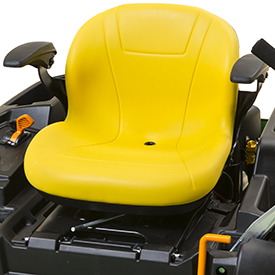 Comfortable seat (Z525E)
Comfortable seat (Z525E)
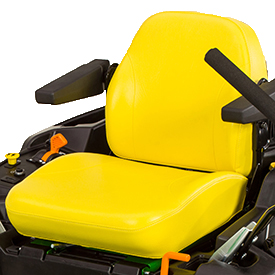 Comfortable seat (Z535M, Z540M)
Comfortable seat (Z535M, Z540M)
 Comfortable seat (Z535R, Z540R)
Comfortable seat (Z535R, Z540R)
Comfortable seats have two suspension springs and no-tools fore-aft seat adjustment that can be used by the operator while seated:
- Z525E – Medium-back, 15-in. (38-cm) seat with adjustable armrests and 3-in. (7.6-cm) fore-aft adjustment
- Z535M – High-back, 18-in. (45.7-cm) seat with adjustable armrests and 3-in. (7.6-cm) fore-aft adjustment
- Z540M – High-back, 18-in. (45.7-cm) seat with adjustable armrests and 3-in. (7.6-cm) fore-aft adjustment
- Z535R – High-back, 21-in. (53.3-cm) seat with adjustable armrests and 4.5-in. (11.4-cm) fore-aft adjustment
- Z540R – High-back, 21-in. (53.3-cm) seat with adjustable armrests and 4.5-in. (11.4-cm) fore-aft adjustment
Seat suspension
 Seat suspension springs
Seat suspension springs
Two steel springs under the seat absorb shocks when traveling over rougher areas to provide a smoother ride.
Cup holder and storage compartment
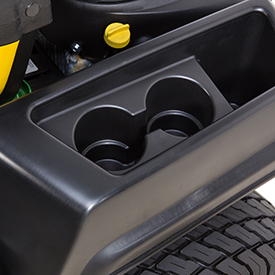 Cup holder (Z525E shown)
Cup holder (Z525E shown)
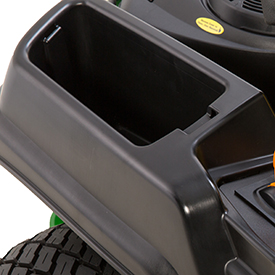 Open storage compartment
Open storage compartment
Flip-up foot platform
 Flip-up foot platform
Flip-up foot platform
The commercial-style steel footrest flips up to provide easy access for servicing the mower deck:
- Easy to clean grass off the top of the mower
- Provides convenient access to the mower drive
Controls are convenient and easy to use
Motion-control levers
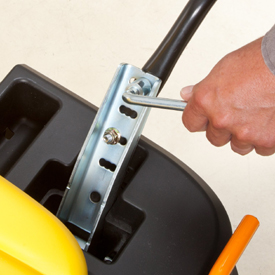 Adjustable motion-control levers
Adjustable motion-control levers
The motion-control levers can be adjusted to three different height settings and fifteen different fore-aft settings:
- Increased operator comfort
- Can adjust for the most precise control of the machine
 Shock absorber for motion-control levers
Shock absorber for motion-control levers
A standard shock absorber for the motion-control levers makes it easy and comfortable to maneuver the ZTrak™ Mowers:
- Shock absorber modulates the movement of the control levers for smoother operation.
- Operator can smoothly and precisely control the machine.
Tracking adjustment
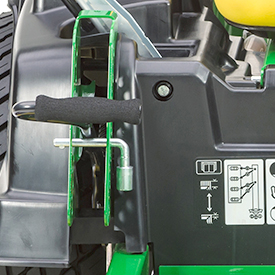 Cut-height pin doubles as tracking adjustment tool
Cut-height pin doubles as tracking adjustment tool
Tracking adjustment from the operator seat is quick and easy. A cut-height pin provides an easy method to adjust the motion-control levers:
-
The socket included on the cut-height pin can be used for the operator to use when making a tracking adjustment.
Control panel
 Control panel
Control panel
The operator control panel is conveniently located and easy to use.
The instruments and controls are as follows:
- Hour meter
- Ignition switch
- Power take-off (PTO) control
- Engine speed control
- Engine choke control
Park brake
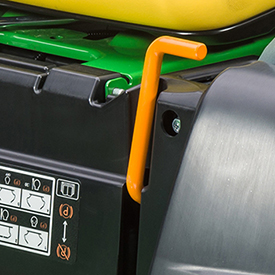 Park brake
Park brake
The park brake is conveniently located:
- Large lever is easy to use.
- Park brake effectively holds the machine in the parked position.
- Park brake must be engaged (in the upper position) to start the engine.
- Once the engine is started, the park brake must be disengaged before operating the motion-control levers.
Mower deck lift/cut-height adjustment
 Cut-height adjustment
Cut-height adjustment
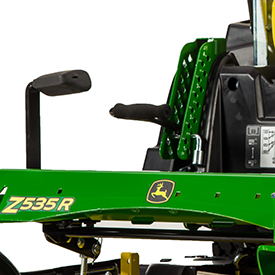 Mower deck lift/cut-height adjustment
Mower deck lift/cut-height adjustment
The Z535R and Z540R include a foot-lift pedal along with the hand-lift lever to make raising the mower deck easier. The foot-lift pedal also provides a convenient way to temporarily raise the mower deck over an obstruction while mowing:
- Mower deck cutting height adjusts from 1 in. (2.5 cm) to 4 in. (10.2 cm) in 0.25-in. (0.64-cm) increments for optimum cut quality and performance.
- Mower deck adjustment has built-in memory so the operator can easily return to the desired cutting height.
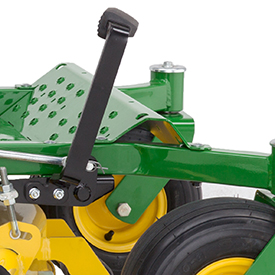 Mower deck lift pedal
Mower deck lift pedal

- Foot pedal provides easy lifting of the deck.
Serviceability is designed-in for convenience
 Service interval decal (Z300 Series shown)
Service interval decal (Z300 Series shown)
 Service interval decal (Z500 Series shown)
Service interval decal (Z500 Series shown)
A convenient service interval decal provides basic maintenance information. It provides a quick-reference for keeping recommended service up to date.
Mower deck access
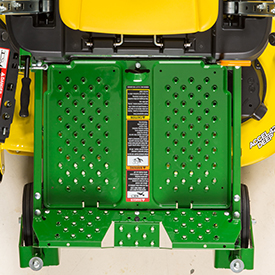 Footrest easily removed for access to mower (Z335E shown)
Footrest easily removed for access to mower (Z335E shown)
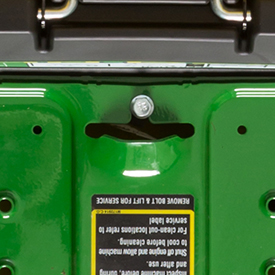 Footrest removal bolt and hand grip (Z335E shown)
Footrest removal bolt and hand grip (Z335E shown)
The footrest area is hinged and easily raised for service to mower deck:
- It is necessary to remove just one bolt that can be conveniently removed with the lift-height pin.
-
Easy to clean grass off the top of the mower
-
Provides convenient access to the mower drive
 Loosening bolt to remove platform for access to mower deck
Loosening bolt to remove platform for access to mower deck
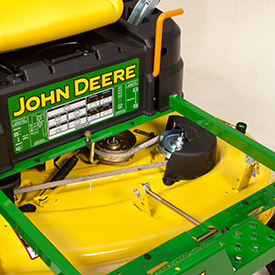 Footrest opens for access to mower deck
Footrest opens for access to mower deck
Engine service
 Z335E engine
Z335E engine
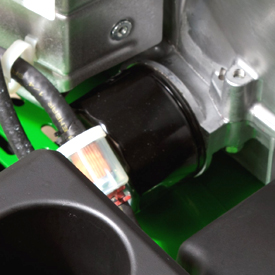 Z335E engine oil and fuel filters shown
Z335E engine oil and fuel filters shown
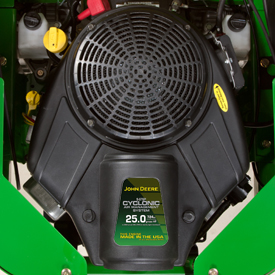 Z535M and Z535R engine
Z535M and Z535R engine
 Z540M and Z540R engine
Z540M and Z540R engine
 Easy-to-access oil filter, fill/check oil tube, and oil drain
Easy-to-access oil filter, fill/check oil tube, and oil drain
The engines are easy to service, including changing the oil and the oil filter and servicing the air filter.
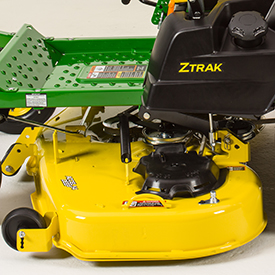 Accel Deep Mower Deck
Accel Deep Mower Deck
 Tie-down locations
Tie-down locations
Accel Deep™ Mower Decks have several features that make them easy to service:
- Flat-top design minimizes places for debris to collect.
- Spring-loaded, flip-up belt guards make removing debris easy.
- Provision is provided for a standard, 3/8-in. (9.5-mm) ratchet wrench to be used for releasing belt tension when removing the drive belt.
Tie-down locations are provided for convenience and safety when trailering the machine.
The Edge™ Cutting System high-capacity (HC) 48-in. (122-cm) Mower Deck handles larger volumes of grass
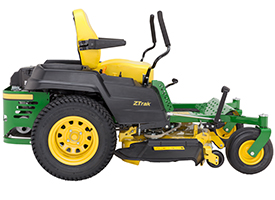 48-in. (122-cm) HC Mower Deck
48-in. (122-cm) HC Mower Deck
The 48-in. (122-cm) HC Mower Deck has a deep-deck design to handle higher volumes of grass. It is stamped from heavy-gauge steel and has additional durability features to stand up to challenging mowing conditions.
 48-in. (122-cm) HC Mower Deck shown on a Z540R
48-in. (122-cm) HC Mower Deck shown on a Z540R
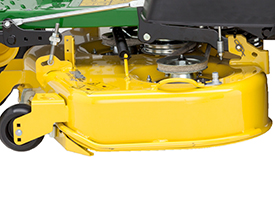 Left side of 48-in. (122-cm) HC Mower Deck
Left side of 48-in. (122-cm) HC Mower Deck
The 48-in. (122-cm) HC Deck is stamped from heavy, 9-gauge, 0.15-in. (3.8-mm) steel to minimize the number of welds and provide a smooth underside for reduced material buildup:
- Deep-deck design of 5.5 in. (14 cm) delivers excellent airflow, so material can be processed quickly and efficiently.
- Wider and higher discharge opening provides even clipping dispersal for an excellent finished appearance in all conditions.
- Durable plastic deflector spreads grass clippings evenly across the lawn, is hinged, and can be raised to minimize the storage space required.
- 1-in. (2.5-cm) cold-forged spindles are heat-treated for strength and are supported by ball bearings.
- Front edge is raised above the blade plane to allow even cutting of tall grass.
- Blade overlap is 1.6 in. (4 cm), nearly 0.8 in. (2 cm) greater than many conventional decks, for a clean cut.
 Mower wash port
Mower wash port
 Mower wash port with hose connector
Mower wash port with hose connector
A wash port is provided to make cleaning the underside of the mower deck easy:
- Hose connector is included with the mower deck.
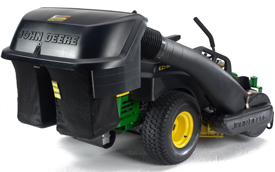 Rear angle of 6.5-bu (230-L) Power Flow™ Rear Bagger shown on Z525E
Rear angle of 6.5-bu (230-L) Power Flow™ Rear Bagger shown on Z525E
 Side view of 6.5-bu (230-L) Power Flow Rear Bagger shown on Z525E
Side view of 6.5-bu (230-L) Power Flow Rear Bagger shown on Z525E
An optional rear bagger is available:
- Mower is designed to fill the 6.5-bu (230-L) rear hopper using the Power Flow blower.
- Standard or mulch blades may be used with the Power Flow collection system.
 Power Flow blower
Power Flow blower

The Power Flow blower is mounted on a sturdy swing arm that allows easy installation and cleanout.
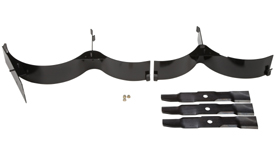 Mulching attachment components
Mulching attachment components

An optional mulching attachment is available:
- This design requires no drilling for initial mounting, less installation time, and reduced hardware-count that allows for easy removal of the mulch components.
- The high-performance mulching attachment includes formed steel baffles to control the material and special mulching blades for superior performance.
- The special mulching blades that are included can also be used for side discharging or with a material collection system, though the overall cut quality may be slightly less than with the standard mower blades.
The Edge™ Cutting System high-capacity (HC) 54-in. (137-cm) Mower Deck
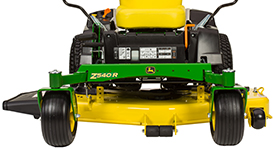 54-in. (137-cm) HC Mower Deck
54-in. (137-cm) HC Mower Deck
The 54-in. (137-cm) HC Mower Deck has a deep-deck design.
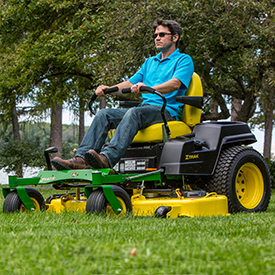 54-in. (137-cm) HC Mower Deck shown on a Z540R
54-in. (137-cm) HC Mower Deck shown on a Z540R
 Reinforced mower edge for durability
Reinforced mower edge for durability
The 54-in. (137-cm) HC Deck is stamped from heavy, 9-gauge, 0.150-in. (3.8-mm) steel to minimize the number of welds and provide a smooth underside for reduced material buildup:
-
Deep-deck design of 5.5 in. (14 cm) delivers excellent airflow, so material can be processed quickly and efficiently.
-
Wider and higher discharge opening provides even clipping dispersal for an excellent finished appearance in all conditions.
- Durable plastic deflector spreads grass clippings evenly across the lawn, is hinged, and can be raised to minimize the storage space required.
-
1-in. (25.4-mm) cold-forged spindles are heat-treated for strength and are supported by ball bearings.
-
Standard front roller and two double-captured anti-scalp wheels give a more even mowing job and reduce the chance of scalping.
-
Front edge is raised above the blade plane to allow even cutting of tall grass.
-
Blade overlap is 1.6 in. (40 mm), nearly 0.8 in. (20 mm) greater than many conventional decks, for a clean cut.
-
Mower can side-discharge or mulch.
 Mower wash port
Mower wash port
 Mower wash port with hose connector
Mower wash port with hose connector
A wash port is provided to make cleaning the underside of the mower deck easy:
-
Hose connector is included with the mower deck.
 Rear angle of 6.5-bu (230-L) Power Flow™ Rear Bagger shown on Z525E
Rear angle of 6.5-bu (230-L) Power Flow™ Rear Bagger shown on Z525E
 Side view of 6.5-bu (230-L) Power Flow Rear Bagger shown on Z525E
Side view of 6.5-bu (230-L) Power Flow Rear Bagger shown on Z525E
An optional rear bagger is available:
- Mower is designed to fill the 6.5-bu (230-L) rear hopper using the Power Flow blower.
- Standard or mulch blades may be used with the Power Flow collection system.
 Power Flow blower
Power Flow blower

The Power Flow blower is mounted on a sturdy swing arm that allows easy installation and cleanout.
Optional high-performance mulching attachment
 Mulching attachment components (48 HC shown)
Mulching attachment components (48 HC shown)

An optional mulching attachment is available:
- This design requires no drilling for initial mounting, less installation time, and reduced hardware-count, that allows for easy removal of the mulch components.
- The high-performance mulching attachment includes formed steel baffles to control the material and special mulching blades for superior performance.
- The special mulching blades that are included can also be used for side discharging or with a material collection system, though the overall cut quality may be slightly less than with the standard mower blades.
- Order: BM23977, 54 HC mulching attachment
Optional MulchControl™ attachment
 MulchControl with baffle closed
MulchControl with baffle closed
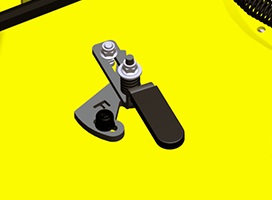 MulchControl handle
MulchControl handle
The MulchControl attachment makes mulching more practical for many mowing situations because it not only does an excellent job of mulching but it also allows the mower to be easily converted for times when it is more desirable to side discharge or collect the lawn material. Advantages of mulching grass clippings include:
- A beautiful looking lawn
- Grass clippings not blown onto the operator, driveways, or flower beds
- Less fertilizer use
- Elimination of the effort needed to dispose of clippings
MulchControl is an innovative, simple design that is easy to use and maintain:
- The MulchControl attachment includes baffles to control the flow of material under the deck.
- The left mower blade area is completely enclosed and optimized for mulching, thus will mulch even when the mower is in the side-discharge mode.
- Baffles around the center and right blades are optimized for mulching when the discharge baffle is closed.
- The MulchControl handle is located on top of the mower deck and used to open and close the discharge baffle.
- The operator is required to get off of the machine in order to engage or disengage mulch mode.
- Changing from mulching to side discharge or vice versa takes only a few seconds.
MulchControl is well-suited to the following mowing situations:
- Usually mulch, but side-discharge when grass gets too long
- Usually side discharge, but would like to be able to close the chute to control clippings
- Always mulch a main lawn, but often side discharge secondary lawns
- Bag clippings, but want to go farther before emptying bags
MulchControl puts the operator in control of the clippings. Now the operator can have all the benefits of mulching with the ability to easily change to side-discharge or bagging when needed.
MulchControl limitations
While in the side-discharge mode, MulchControl will still mulch about one third of the material. Therefore, the side-discharge mode is essentially a partial-mulch mode. This can be an advantage when side discharging or bagging, as it helps to reduce the amount of material being discharged. Other times this could work as a disadvantage:
- When cutting strong southern grasses, such as Zoysia and Bermuda
- When cutting in wet, high-growth conditions, such as those found in the Pacific Northwest United States
- When optimum bagging and lawn clean-up is desired
MulchControl compatibility
MulchControl is a field-installed attachment. Mulching blades are included:
- MulchControl is available for 2015 and later EZtrak™ Z625 and Z655 (SN 170,001-).
Order:
The Edge™ Cutting System High-Capacity (HC) 60-in. (152-cm) Mower Deck
 60-in. (152-cm) HC Mower Deck
60-in. (152-cm) HC Mower Deck

The 60-in. (152-cm) HC Mower Deck has a deep-deck design.
 60-in. (152-cm) HC Mower Deck shown on a Z540R
60-in. (152-cm) HC Mower Deck shown on a Z540R
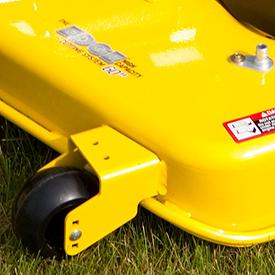 Reinforced mower edge for durability
Reinforced mower edge for durability
The 60-in. (152-cm) HC Deck is stamped from heavy, 9-gauge, 0.15-in. (3.8-mm) steel to minimize the number of welds and provide a smooth underside for reduced material buildup:
- Deep-deck design delivers excellent airflow, so material can be processed quickly and efficiently.
- Wider and higher discharge opening provides even clipping dispersal for an excellent finished appearance in all conditions.
- Durable plastic deflector spreads grass clippings evenly across the lawn, is hinged, and can be raised to minimize the storage space required.
- 1-in. (25.4-mm) cold-forged spindles are heat-treated for strength and are supported by ball bearings.
- Standard front roller and two double-captured anti-scalp wheels give a more even mowing job and reduce the chance of scalping.
- Front edge is raised above the blade plane to allow even cutting of tall grass.
- Blade overlap is greater than many conventional decks, for a clean cut.
- Mower can side-discharge or mulch.
 Mower wash port
Mower wash port
 Mower wash port with hose connector
Mower wash port with hose connector
A wash port is provided to make cleaning the underside of the mower deck easy:
- Hose connector is included with the mower deck.
Optional high-performance mulching attachment
 Mulching attachment components (48 HC shown)
Mulching attachment components (48 HC shown)

An optional mulching attachment is available:
- This design requires no drilling for initial mounting, less installation time, and reduced hardware-count that allows for easy removal of the mulch components.
- The high-performance mulching attachment that includes formed steel baffles to control the material and special mulching blades for superior performance.
- The special mulching blades that are included can also be used for side discharging, though overall performance may be slightly less than with the standard mower blades.
- Order: BM23978, 60 HC mulching attachment
Optional MulchControl™ attachment
 MulchControl with baffle closed
MulchControl with baffle closed
 MulchControl handle
MulchControl handle
The MulchControl attachment makes mulching more practical for many mowing situations because it not only does an excellent job of mulching but it also allows the mower to be easily converted for times when it is more desirable to side discharge the lawn material. Advantages of mulching grass clippings include:
- A beautiful looking lawn
- Grass clippings not blown onto the operator, driveways, or flower beds
- Less fertilizer use
- Elimination of the effort needed to dispose of clippings
MulchControl is an innovative, simple design that is easy to use and maintain:
- The MulchControl attachment includes baffles to control the flow of material under the deck.
- The left mower blade area is completely enclosed and optimized for mulching, thus will mulch even when the mower is in the side-discharge mode.
- Baffles around the center and right blades are optimized for mulching when the discharge baffle is closed.
- The MulchControl handle is located on top of the mower deck and used to open and close the discharge baffle.
- The operator is required to get off of the machine in order to engage or disengage mulch mode.
- Changing from mulching to side discharge or vice versa takes only a few seconds.
MulchControl is well-suited to the following mowing situations:
- Usually mulch, but side-discharge when grass gets too long
- Usually side discharge, but would like to be able to close the chute to control clippings
- Always mulch a main lawn, but often side discharge secondary lawns
MulchControl puts the operator in control of the clippings. Now the operator can have all the benefits of mulching with the ability to easily change to the side-discharge mode when needed.
MulchControl limitations
While in the side-discharge mode, MulchControl will still mulch about one third of the material. Therefore, the side-discharge mode is essentially a partial-mulch mode. This can be an advantage when side discharging, as it helps to reduce the amount of material being discharged. Other times this could work as a disadvantage:
- When cutting strong southern grasses, such as Zoysia and Bermuda
- When cutting in wet, high-growth conditions, such as those found in the Pacific Northwest United States
- When optimum lawn clean-up is desired
MulchControl compatibility
MulchControl is a field-installed attachment. Mulching blades are included:
- MulchControl is for 2015 and later EZtrak™ Z665 Mower (SN 170,001-) and ZTrak™ Z540R Mower.
Order:
Features
Design includes a heavy-duty formed and welded steel frame
 ZTrak™ Z335E shown
ZTrak™ Z335E shown
 ZTrak Z535M shown
ZTrak Z535M shown
ZTrak Mowers are designed around a heavy-duty formed and welded steel frame for strength and reliability.
Large front caster wheels and large rear drive wheels provide several operator benefits:
-
Smoother ride
-
Better slope performance
-
More operator comfort over uneven ground
-
Better traction
The operator platform is roomy and uncluttered for maximum comfort, and the controls are convenient to use:
- Easy to get on and off the mower
- Ample legroom for comfortable operation
- Adjustable motion-control levers for height and position, enabling the operator to stay comfortable while using them
- Color-coded and logically placed controls
Engine is smooth and powerful V-twin design with features for reliability and long life
 24-hp (17.9-kW) engine
24-hp (17.9-kW) engine
 Overhead valve engine
Overhead valve engine
Key engine features include:
- 24 hp (17.9 kW) provides plenty of power.
- Large 44.3 cu in. (726-cc) displacement provides plenty of torque.
- V-twin air-cooled design is efficient.
- Excellent power and performance
- Smooth, quiet power
- Easy starts
- Engine model FS730V
- Many quality features are included.
- Cast-iron cylinder liners provide a long-wearing surface for longer engine life.
- Overhead valves allow the engine to breathe easily for excellent power and fuel economy.
- Full-pressure lubrication is more effective.
- Replaceable oil filter keeps the oil cleaner for longer engine life.
- Dual-stage air cleaner thoroughly cleans engine intake air.
- Electronic ignition contributes to fast starts.
- Solenoid-shift starter for easy starts, even in cold weather.
- Rear engine guard protects the engine and provides additional vehicle strength and integrity.
- A flywheel alternator provides plenty of capacity to quickly recharge the battery and power electrical equipment, such as lights or a sprayer.
- 20-amp capacity
- Regulated to keep the battery at a full charge, without risk of overcharging
 Air filter cover
Air filter cover
 Cover removed to show air filter
Cover removed to show air filter
First-stage foam filter stops large dirt particles before they make contact with the filter.
The air filter is easily removed for cleaning or replacement.
 Engine cooling-air screen
Engine cooling-air screen
 Engine oil fill, filter, and drain
Engine oil fill, filter, and drain
Air screen cover provides protection for the rotating air screen. Rotating screen filters out debris and reduces the size of material that gets through so it will pass harmlessly past the engine fins.
Full-pressure lubrication system provides plenty of oil to the engines moving parts to ensure reliable operation and long life:
-
Replaceable oil filter keeps the oil cleaner for a longer engine life.
-
Extends the time between oil changes
-
-
Full-pressure lubrication is more effective.
-
No-tools oil drain is convenient to use.
John Deere recommends the use of fuel stabilizer in gasoline. See Fuel-Protect for gasoline engines (8 oz [237 mL]) for more information.
Operator station is designed for comfort and convenience
 Operator station (Z535M shown)
Operator station (Z535M shown)
 Color-coded controls are easy to identify
Color-coded controls are easy to identify
The operator station is designed for operator comfort and convenience in operating all controls:
- Excellent visibility forward and to the trim side of the deck makes operation easy and comfortable for the operator.
- Controls are color coded for easy identification.
- Twin-lever motion-control levers adjust, using cut-height pin/socket, for convenience and operator comfort.
- Shock absorbers dampen control movements to give smooth operation.
Comfortable seat
 Comfortable seat (Z525E)
Comfortable seat (Z525E)
 Comfortable seat (Z535M, Z540M)
Comfortable seat (Z535M, Z540M)
 Comfortable seat (Z535R, Z540R)
Comfortable seat (Z535R, Z540R)
Comfortable seats have two suspension springs and no-tools fore-aft seat adjustment that can be used by the operator while seated:
- Z525E – Medium-back, 15-in. (38-cm) seat with adjustable armrests and 3-in. (7.6-cm) fore-aft adjustment
- Z535M – High-back, 18-in. (45.7-cm) seat with adjustable armrests and 3-in. (7.6-cm) fore-aft adjustment
- Z540M – High-back, 18-in. (45.7-cm) seat with adjustable armrests and 3-in. (7.6-cm) fore-aft adjustment
- Z535R – High-back, 21-in. (53.3-cm) seat with adjustable armrests and 4.5-in. (11.4-cm) fore-aft adjustment
- Z540R – High-back, 21-in. (53.3-cm) seat with adjustable armrests and 4.5-in. (11.4-cm) fore-aft adjustment
Seat suspension
 Seat suspension springs
Seat suspension springs
Two steel springs under the seat absorb shocks when traveling over rougher areas to provide a smoother ride.
Cup holder and storage compartment
 Cup holder (Z525E shown)
Cup holder (Z525E shown)
 Open storage compartment
Open storage compartment
Flip-up foot platform
 Flip-up foot platform
Flip-up foot platform
The commercial-style steel footrest flips up to provide easy access for servicing the mower deck:
- Easy to clean grass off the top of the mower
- Provides convenient access to the mower drive
Conveniently located fuel-sight window allows operator to see fuel level
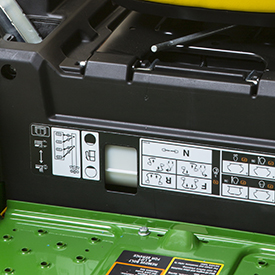 Easy to view fuel level (fuel-sight window)
Easy to view fuel level (fuel-sight window)
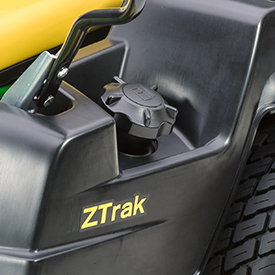 Easy-to-fill fuel tank
Easy-to-fill fuel tank
A convenient fuel-sight window is located where it is easy for the operator to see:
- Semi-clear material makes seeing how much fuel is in the tank quick and easy.
- Large, 3-in. (7.6-cm) fuel-fill opening reduces the chance of spilling when adding fuel.
- Fuel-fill opening is low and angled to make adding fuel easy.
- Cap is tethered to the fuel tank.
- Less chance of fuel cap getting lost
Serviceability is designed-in for convenience
 Service interval decal (Z300 Series shown)
Service interval decal (Z300 Series shown)
 Service interval decal (Z500 Series shown)
Service interval decal (Z500 Series shown)
A convenient service interval decal provides basic maintenance information. It provides a quick-reference for keeping recommended service up to date.
Mower deck access
 Footrest easily removed for access to mower (Z335E shown)
Footrest easily removed for access to mower (Z335E shown)
 Footrest removal bolt and hand grip (Z335E shown)
Footrest removal bolt and hand grip (Z335E shown)
The footrest area is hinged and easily raised for service to mower deck:
- It is necessary to remove just one bolt that can be conveniently removed with the lift-height pin.
-
Easy to clean grass off the top of the mower
-
Provides convenient access to the mower drive
 Loosening bolt to remove platform for access to mower deck
Loosening bolt to remove platform for access to mower deck
 Footrest opens for access to mower deck
Footrest opens for access to mower deck
Engine service
 Z335E engine
Z335E engine
 Z335E engine oil and fuel filters shown
Z335E engine oil and fuel filters shown
 Z535M and Z535R engine
Z535M and Z535R engine
 Z540M and Z540R engine
Z540M and Z540R engine
 Easy-to-access oil filter, fill/check oil tube, and oil drain
Easy-to-access oil filter, fill/check oil tube, and oil drain
The engines are easy to service, including changing the oil and the oil filter and servicing the air filter.
 Accel Deep Mower Deck
Accel Deep Mower Deck
 Tie-down locations
Tie-down locations
Accel Deep™ Mower Decks have several features that make them easy to service:
- Flat-top design minimizes places for debris to collect.
- Spring-loaded, flip-up belt guards make removing debris easy.
- Provision is provided for a standard, 3/8-in. (9.5-mm) ratchet wrench to be used for releasing belt tension when removing the drive belt.
Tie-down locations are provided for convenience and safety when trailering the machine.
The 48-in. (122-cm) Accel Deep™ (48A) Mower Deck cuts clean and is versatile
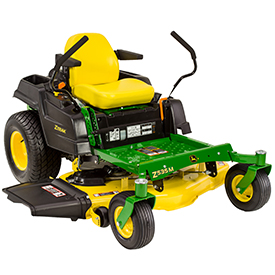 Z535M ZTrak™ Mower with Accel Deep 48A Mower
Z535M ZTrak™ Mower with Accel Deep 48A Mower
 Accel Deep 48A Mower
Accel Deep 48A Mower
The 48-in. (122-cm) Accel Deep Mower Deck is a stamped-steel, deep, flat-top design that delivers excellent cut quality, productivity, cleanliness, durability, and versatility. Optimal performance and dispersion of clippings is provided, even at faster mowing speeds:
- 4.5-in. (11.4-cm) deep throughout the entire deck shell for optimum mowing, mulching, and bagging performance
- Optional MulchControl™ attachment provides superior mulching performance and versatility.
- Stamped-steel design eliminates sharp edges and corners where material can build up and diminish mowing performance
- Mower deck is suspended from the vehicle for a smooth and level cut
- Adjustable mower wheels, positioned just above ground level, help smooth out the mowing job
Excellent cut quality
 48A Mower top (similar mower from X700 Series Tractor shown)
48A Mower top (similar mower from X700 Series Tractor shown)
 48A Mower underside (similar mower from X700 Series Tractor shown)
48A Mower underside (similar mower from X700 Series Tractor shown)
Deep mower-deck stamping gives excellent cut quality. It allows the cut and suspended material room to exit the deck without getting recut:
- Reducing the amount of re-cutting enables more power to be used to cut incoming grass, which greatly improves mower capacity.
- Helps maintain excellent cut quality at faster mowing speeds
- Clean flow of material out of discharge area prevents cut material from interfering with cutting the incoming grass, making it possible for the blades to cut incoming material cleanly.
- Even in mulching mode, cut evenness is improved compared to other designs because the additional depth allows for continuous circulation, optimal re-cutting, and an even distribution of clippings.
Productivity - getting the job done fast
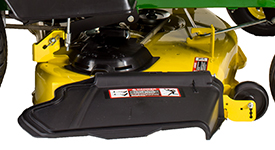 Right side of Accel Deep 48A Mower Deck
Right side of Accel Deep 48A Mower Deck
Deep mower-deck stamping gives high productivity, which gets the job done fast. It allows the cut and suspended material room to exit the deck quickly, reducing the amount of recutting so more power is available to process incoming grass:
- Greatly improves mowers capacity to maintain excellent mowing performance in difficult mowing conditions and at higher speeds
Large discharge opening is both high and wide to handle more material:
- Gives a smooth, even discharge of clippings at all mowing speeds
- Reduces the chance of plugging, especially important when operating in wet, thick, or dense grass and when bagging
- The 48A Power Flow™ blower has an inlet housing with over 50 percent greater area than the 48X Power Flow blower used on previous machines.
Cleanliness - for the mower and the operator
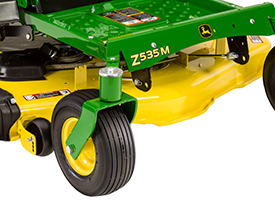 Accel Deep 48A Mower Deck
Accel Deep 48A Mower Deck
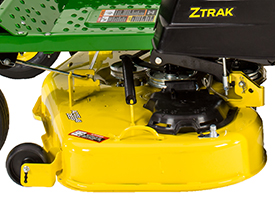 Accel Deep 48A Mower Deck
Accel Deep 48A Mower Deck
The flat-top shape of the deck stamping is optimal for keeping itself and the operator clean:
- There are few places to catch and hold material on top and underneath the deck.
- Top of deck stays cleaner, reducing time and effort needed for cleaning and service
- Underside of deck is self-cleaning to maintain optimum performance without buildup of material to interfere with the flow of air and clippings
- Less need to clean and remove buildup of material from underside deck
- The depth of the Accel Deep Mower Deck minimizes the amount of material that escapes from the front of the deck
- Limited amount of material to drift onto the operator and mower deck
- Even for material discharged out the chute, less recutting results in larger pieces that are less likely to end up on the operator
- Mulching prevents the discharge of material completely and the MulchControl attachment makes mulching a practical solution for most mowing situations.
Cleaning a mower deck, both top and bottom, is one of the most frequent maintenance activities:
- The flat-top design reduces places for material to build up and makes material that does collect easy to remove.
 Mower wash port
Mower wash port
 Mower wash port with hose connector
Mower wash port with hose connector
A wash port is provided to make cleaning the underside of the mower deck easy.
- Hose connector is included with the mower deck.
Superior durability is designed in
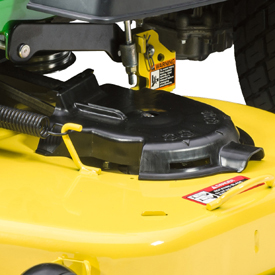 Spindle pocket
Spindle pocket
 Mower wheels are double captured
Mower wheels are double captured
The 48A Mower Deck has strong spindle pockets, to keep the blades aligned, even after years of tough service:
- Ribs in the deck shell add strength where it is needed.
- The 48A has a 23 percent heavier overall weight than the Edge™ Xtra 48-in. (122-cm) Mower Deck used on previous machines.
Mower wheels are double-captured:
- Provides greater strength and durability for longer, trouble-free life.
- Single-bolt adjustment makes setting wheels to the correct height for the cutting height quick and easy.
Low-tension belt-drive design reduces the side load on engine lower bearings and mower deck bearings for longer life.
The 48A Mower Deck features a 5/8-in. (16-mm) diameter solid-steel rod side bumper that provides extra strength and protection.
Dual-stage E-coat and powder-paint coatings provide extra protection from rust.
Versatility - easy to change between side discharge, mulch, and bagging modes
The 48A Mower is designed for maximum versatility, providing the greatest ease in changing from one mower discharge mode to another:
- With the optional MulchControl attachment installed (along with the special mulching blades), changing from side-discharge to mulching or vice versa is done with the simple flip of a lever.
- The Power Flow rear bagger can be used with the MulchControl attachment and blades installed - by simply placing the MulchControl lever in the side-discharge position.
MulchControl option
The MulchControl attachment for the 48A Mower Deck makes mulching more practical for many mowing situations because it not only does an excellent job of mulching but it also allows the mower to be easily converted for times when it is more desirable to side discharge or collect the lawn material. Advantages of mulching grass clippings include:
- A beautiful looking lawn
- Grass clippings not blown onto the operator, driveways, or flower beds
- Less fertilizer use
- Elimination of the effort needed to dispose of clippings
How MulchControl works
 MulchControl baffle open (similar mower from X700 Series Tractor shown)
MulchControl baffle open (similar mower from X700 Series Tractor shown)
 MulchControl baffle closed (similar mower from X700 Series Tractor shown)
MulchControl baffle closed (similar mower from X700 Series Tractor shown)
MulchControl is an innovative, simple design that is easy to use and maintain:
- The MulchControl attachment includes baffles to control the flow of material under the deck.
- The MulchControl baffle, or divider, between the left and middle spindles is about half way down. The height is designed to balance the mulching and side-discharge modes.
- When the MulchControl baffle is open, the divider between the left and middle spindles passes a portion of the material to the discharge opening, along with the material from the middle and right spindle areas.
- When the MulchControl baffle is closed, the material stays within the deck and gets chopped into mulch and deposited in the turf.
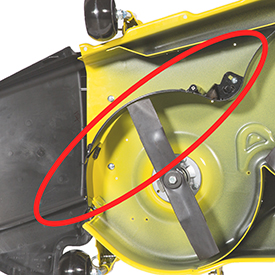 MulchControl baffle closed
MulchControl baffle closed
 MulchControl handle
MulchControl handle
- The MulchControl handle is located on top of the mower deck and used to open and close the discharge baffle.
- The operator is required to get off of the machine in order to engage or disengage mulch mode.
- Changing from mulching to side discharge or vice versa takes only a few seconds.
MulchControl is well-suited to the following mowing situations:
- Usually mulch, but side discharge when grass gets too long
- Usually side-discharge, but would like to be able to close the chute to control clippings
- Always mulch a main lawn, but often side discharge secondary lawns
- Bag clippings, but want to go farther before emptying bags
MulchControl puts the operator in control of the clippings. Now the operator can have all the benefits of mulching with the ability to easily change to side discharge or bagging when needed.
While in the side-discharge mode, MulchControl will still mulch about one-third of the material. Therefore, the side-discharge mode is essentially a partial-mulch mode. This can be an advantage when side discharging or bagging, as it helps to reduce the amount of material being discharged. Other times this could work as a disadvantage:
- When cutting strong southern grasses, such as Zoysia and Bermuda
- When cutting in wet, high-growth conditions, such as those found in the Pacific Northwest United States
- When optimum bagging and lawn clean-up is desired
6.5-bu (230-L) Power Flow rear bagger (rear bagger not available for ZTrak Z355E or Z355R)
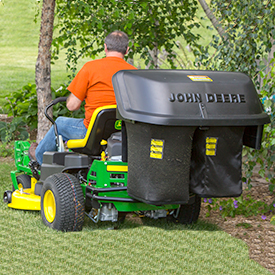 Optional rear bagger
Optional rear bagger
 Power Flow blower
Power Flow blower
An optional 6.5-bu (230-L) Power Flow Rear Bagger material collection system (MCS) is available. It provides an efficient means of collecting grass clippings and leaves:
- The Power Flow blower and chute are easy to install. The Power Flow blower swings out for easy cleanout and cleanup.
- The hopper design provides modern styling, great bagging performance, cleaner operation, and easy-to-empty bags:
- 6.5-bu (230-L) capacity
- Easy-to-attach Power Flow blower (ordered separately)
- Easy-to-attach chute (ordered separately)
- Air exhaust duct
- Convenient spring-latch
- Airflow fill indicator
- Quik-Tatch mounting
- Sealed hopper top
- Loose-knit bags available
The 54-in. (138-cm) Accel Deep™ (54A) Mower Deck cuts clean and is versatile
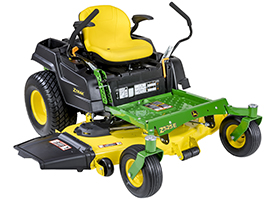 Z525E ZTrak™ Mower with Accel Deep 54A Mower
Z525E ZTrak™ Mower with Accel Deep 54A Mower
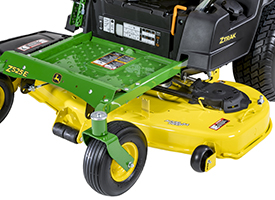 Accel Deep 54A Mower
Accel Deep 54A Mower
The 54-in. (138-cm) Accel Deep Mower Deck is a stamped-steel, deep, flat-top design that delivers excellent cut quality, productivity, cleanliness, durability, and versatility. Optimal performance and dispersion of clippings is provided, even at faster mowing speeds:
- 4.5-in. (11.4-cm) deep throughout the entire deck shell for optimum mowing, mulching, and bagging performance
- Optional MulchControl™ attachment provides superior mulching performance and versatility.
- Stamped-steel design eliminates sharp edges and corners where material can build up and diminish mowing performance
- Mower deck is suspended from the vehicle for a smooth and level cut
- Adjustable mower wheels, positioned just above ground level, help smooth out the mowing job
Excellent cut quality
 54A Mower top (similar mower from X500 Series Tractor shown)
54A Mower top (similar mower from X500 Series Tractor shown)
 54A Mower underside (similar mower from X500 Series Tractor shown)
54A Mower underside (similar mower from X500 Series Tractor shown)
Deep mower-deck stamping gives excellent cut quality. It allows the cut and suspended material room to exit the deck without getting recut:
- Reducing the amount of recutting enables more power to be used to cut incoming grass, which greatly improves mower capacity.
- Helps maintain excellent cut quality at faster mowing speeds
- Clean flow of material out of discharge area prevents cut material from interfering with cutting the incoming grass, making it possible for the blades to cut incoming material cleanly.
- Even in mulching mode, cut evenness is improved compared to other designs because the additional depth allows for continuous circulation, optimal recutting, and an even distribution of clippings.
Productivity - getting the job done fast
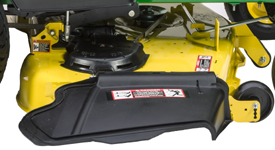 Right side of Accel Deep 54A Mower Deck
Right side of Accel Deep 54A Mower Deck
Deep mower-deck stamping gives high productivity, which gets the job done fast. It allows the cut and suspended material room to exit the deck quickly, reducing the amount of re-cutting so more power is available to process incoming grass:
- Greatly improves mowers capacity to maintain excellent mowing performance in difficult mowing conditions and at higher speeds
Large discharge opening is both high and wide to handle more material:
- Gives a smooth, even discharge of clippings at all mowing speeds
- Reduces the chance of plugging, especially important when operating in wet, thick, or dense grass and when bagging
- The 54A Power Flow™ blower has an inlet housing with over 50 percent greater area than the 48X Power Flow blower used on previous machines.
Cleanliness - for the mower and the operator
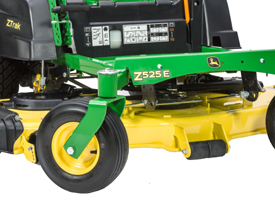 Accel Deep 54A Mower Deck
Accel Deep 54A Mower Deck
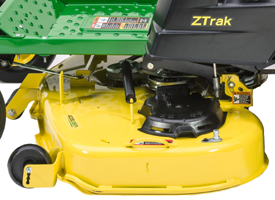 Accel Deep 54A Mower Deck
Accel Deep 54A Mower Deck
The flat-top shape of the deck stamping is optimal for keeping itself and the operator clean:
- There are few places to catch and hold material on top and underneath the deck.
- Top of deck stays cleaner, reducing time and effort needed for cleaning and service
- Underside of deck is self-cleaning to maintain optimum performance without buildup of material to interfere with the flow of air and clippings
- Less need to clean and remove build-up of material from underside deck
- The depth of the Accel Deep Mower Deck minimizes the amount of material that escapes from the front of the deck
- Limited amount of material to drift onto the operator and mower deck
- Even for material discharged out the chute, less re-cutting results in larger pieces that are less likely to end up on the operator
- Mulching prevents the discharge of material completely and the MulchControl attachment makes mulching a practical solution for most mowing situations.
Cleaning a mower deck, both top and bottom, is one of the most frequent maintenance activities:
- The flat-top design reduces places for material to build up and makes material that does collect easy to remove.
 Mower wash port
Mower wash port
 Mower wash port with hose connector
Mower wash port with hose connector
A wash port is provided to make cleaning the underside of the mower deck easy.
- Hose connector is included with the mower deck.
Superior durability is designed in
 Spindle pocket
Spindle pocket
 Mower wheels are double captured
Mower wheels are double captured
The 54A Mower Deck has strong spindle pockets, to keep the blades aligned, even after years of tough service:
- Ribs in the deck shell add strength where it is needed.
Mower wheels are double captured:
- Provides greater strength and durability for longer, trouble-free life.
- Single-bolt adjustment makes setting wheels to the correct height for the cutting height quick and easy.
Low-tension belt-drive design reduces the side load on engine lower bearings and mower deck bearings for longer life.
The 54A Mower Deck features a 5/8-in. (16-mm) diameter solid-steel rod side bumper that provides extra strength and protection.
Dual-stage E-coat and powder-paint coatings provide extra protection from rust.
Versatility - easy to change between side discharge, mulch, and bagging modes
The 54A Mower is designed for maximum versatility, providing the greatest ease in changing from one mower discharge mode to another:
- With the optional MulchControl attachment installed (along with the special mulching blades), changing from side discharge to mulching or vice versa is done with the simple flip of a lever.
- The Power Flow rear bagger can be used with the MulchControl attachment and blades installed - by simply placing the MulchControl lever in the side discharge position.
MulchControl option
The MulchControl attachment for the 54A Mower Deck makes mulching more practical for many mowing situations because it not only does an excellent job of mulching but it also allows the mower to be easily converted for times when it is more desirable to side discharge or collect the lawn material. Advantages of mulching grass clippings include:
- A beautiful looking lawn
- Grass clippings not blown onto the operator, driveways, or flower beds
- Less fertilizer use
- Elimination of the effort needed to dispose of clippings
How MulchControl works
 MulchControl baffle open
MulchControl baffle open
 MulchControl baffle closed
MulchControl baffle closed
MulchControl is an innovative, simple design that is easy to use and maintain:
- The MulchControl attachment includes baffles to control the flow of material under the deck.
The MulchControl baffle, or divider, between the left and middle spindles is about half way down. The height is designed to balance the mulching and side-discharge modes.
When the MulchControl baffle is open, the divider between the left and middle spindles passes a portion of the material to the discharge opening, along with the material from the middle and right spindle areas.
- When the MulchControl baffle is closed, the material stays within the deck and gets chopped into mulch and deposited in the turf.
 MulchControl baffle closed
MulchControl baffle closed
 MulchControl handle
MulchControl handle
- The MulchControl handle is located on top of the mower deck and used to open and close the discharge baffle.
- The operator is required to get off of the machine in order to engage or disengage mulch mode.
- Changing from mulching to side discharge or vice versa takes only a few seconds.
MulchControl is well-suited to the following mowing situations:
- Usually mulch, but side discharge when grass gets too long
- Usually side-discharge, but would like to be able to close the chute to control clippings
- Always mulch a main lawn, but often side discharge secondary lawns
- Bag clippings, but want to go farther before emptying bags
MulchControl puts the operator in control of the clippings. Now the operator can have all the benefits of mulching with the ability to easily change to side discharge or bagging when needed.
While in the side-discharge mode, MulchControl will still mulch about one third of the material. Therefore, the side-discharge mode is essentially a partial-mulch mode. This can be an advantage when side discharging or bagging, as it helps to reduce the amount of material being discharged. Other times this could work as a disadvantage:
- When cutting strong southern grasses, such as Zoysia and Bermuda
- When cutting in wet, high-growth conditions, such as those found in the Pacific Northwest United States
- When optimum bagging and lawn clean-up is desired
6.5-bu (230-L) Power Flow Rear Bagger (rear bagger not available for ZTrak Z375R)
 Optional rear bagger
Optional rear bagger
 Power Flow blower
Power Flow blower
An optional 6.5-bu (230-L) rear bagger material collection system (MCS) is available. It provides an efficient means of collecting grass clippings and leaves:
- The Power Flow blower and chute are easy to install. The Power Flow blower swings out for easy cleanout and cleanup.
- The hopper design provides modern styling, great bagging performance, cleaner operation, and easy-to-empty bags:
- 6.5-bu (230-L) capacity
- Easy-to-attach Power Flow blower (ordered separately)
- Easy-to-attach chute (ordered separately)
- Air exhaust duct
- Convenient spring-latch
- Airflow fill indicator
- Quik-Tatch mounting
- Sealed hopper top
- Loose-knit bags available
- Hopper kit comes with ballast bracket and (4) weights
The Edge™ Cutting System 62-in. (157-cm) Mower Deck can take on the biggest mowing jobs
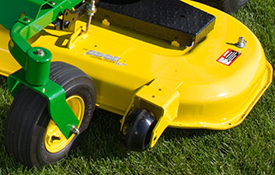 Z540M with 62-in. (157-cm) Edge Mower Deck
Z540M with 62-in. (157-cm) Edge Mower Deck
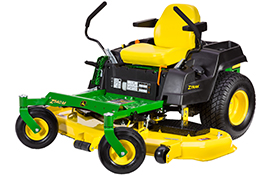 62-in. (157-cm) Edge Mower Deck on Z540M
62-in. (157-cm) Edge Mower Deck on Z540M
The 62-in. (157-cm) Mower is a deep-deck design:
-
Mower can side-discharge or mulch.
- Durable plastic deflector spreads grass clippings evenly across the lawn, is hinged, and can be raised to minimize the storage space required.
Features of the 62-in. (157-cm) Mower Deck include:
- Deep-deck design does a superior job of lifting grass for a clean, even cut.
- Smooth underside of the mower prevents grass buildup and evenly disperses grass clippings.
- Mower deck is stamped from heavy, 10-gauge, 0.135-in. (3.4-mm) steel for superior durability and long life.
- Rolled outer edge of the deck provides extra strength and protection.
- Dual-stage E-coat and powder-paint coatings provide extra protection from rust.
 Mower wash port
Mower wash port
 Mower wash port with hose connector
Mower wash port with hose connector
A wash port is provided to make cleaning the underside of the mower deck easy:
-
Hose connector is included with the mower deck.
 Mulching attachment shown on X500 Tractor mower
Mulching attachment shown on X500 Tractor mower

An optional mulching attachment is available:
- This is a high-performance mulching attachment that includes a mulch plug and special mulching blades.
- The special mulching blades included can also be used for side discharging, though the overall cut quality may decline slightly.
Features
Design includes a heavy-duty formed and welded steel frame
 ZTrak™ Z335E shown
ZTrak™ Z335E shown
 ZTrak Z535M shown
ZTrak Z535M shown
ZTrak Mowers are designed around a heavy-duty formed and welded steel frame for strength and reliability.
Large front caster wheels and large rear drive wheels provide several operator benefits:
-
Smoother ride
-
Better slope performance
-
More operator comfort over uneven ground
-
Better traction
The operator platform is roomy and uncluttered for maximum comfort, and the controls are convenient to use:
- Easy to get on and off the mower
- Ample legroom for comfortable operation
- Adjustable motion-control levers for height and position, enabling the operator to stay comfortable while using them
- Color-coded and logically placed controls
Engine is smooth and powerful V-twin design with features for reliability and long life
 25-hp (18.6-kW) engine in vehicle
25-hp (18.6-kW) engine in vehicle
A 25-hp (18.6-kW) V-twin engine provides plenty of power and torque to handle tough mulching, mowing, and bagging conditions:
- V-twin cylinder design gives greater torque, lower vibration, and improved sound quality.
- Engine model M44 Cyclonic™
- Electronic ignition contributes to fast starts.
- Cast-iron cylinder sleeves provide a long-wearing surface for longer engine life.
- Overhead valves allow the engine to breathe easily for excellent power and fuel economy.
Rear engine guard protects the engine and provides additional vehicle strength and integrity.
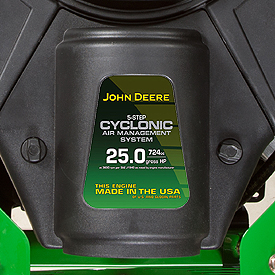 Cyclonic air cleaner
Cyclonic air cleaner
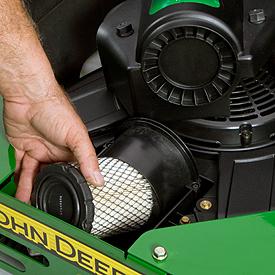 Replaceable air filter
Replaceable air filter
Cyclonic air-management system removes larger particles of dirt before they reach the air filter for reduced filter maintenance and longer engine life:
- Cyclonic design ejects large dirt particles before they make contact with the filter.
- Large, high-quality dry-type paper element air filter thoroughly cleans engine intake air.
- The air filter is easily removed for cleaning or replacement.
 Replaceable oil filter and in-line fuel filter
Replaceable oil filter and in-line fuel filter
Full-pressure lubrication system provides plenty of oil to the engines moving parts to ensure reliable operation and long life:
- Replaceable oil filter keeps the oil cleaner for a longer engine life.
- Extends the time between oil changes
- Full-pressure lubrication is more effective when operating on an incline.
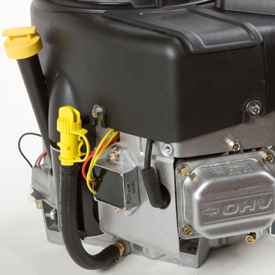 Engine oil-fill cap and oil-drain hose
Engine oil-fill cap and oil-drain hose
No-tools oil-drain cap with hose and oil filter drip tray are provided for easy, no-mess maintenance.
John Deere recommends the use of fuel stabilizer in gasoline. See] Fuel-Protect for gasoline engines (8 oz [237 mL]) for more information.
Operator station is designed for comfort and convenience
 Operator station (Z535M shown)
Operator station (Z535M shown)
 Color-coded controls are easy to identify
Color-coded controls are easy to identify
The operator station is designed for operator comfort and convenience in operating all controls:
- Excellent visibility forward and to the trim side of the deck makes operation easy and comfortable for the operator.
- Controls are color coded for easy identification.
- Twin-lever motion-control levers adjust, using cut-height pin/socket, for convenience and operator comfort.
- Shock absorbers dampen control movements to give smooth operation.
Comfortable seat
 Comfortable seat (Z525E)
Comfortable seat (Z525E)
 Comfortable seat (Z535M, Z540M)
Comfortable seat (Z535M, Z540M)
 Comfortable seat (Z535R, Z540R)
Comfortable seat (Z535R, Z540R)
Comfortable seats have two suspension springs and no-tools fore-aft seat adjustment that can be used by the operator while seated:
- Z525E – Medium-back, 15-in. (38-cm) seat with adjustable armrests and 3-in. (7.6-cm) fore-aft adjustment
- Z535M – High-back, 18-in. (45.7-cm) seat with adjustable armrests and 3-in. (7.6-cm) fore-aft adjustment
- Z540M – High-back, 18-in. (45.7-cm) seat with adjustable armrests and 3-in. (7.6-cm) fore-aft adjustment
- Z535R – High-back, 21-in. (53.3-cm) seat with adjustable armrests and 4.5-in. (11.4-cm) fore-aft adjustment
- Z540R – High-back, 21-in. (53.3-cm) seat with adjustable armrests and 4.5-in. (11.4-cm) fore-aft adjustment
Seat suspension
 Seat suspension springs
Seat suspension springs
Two steel springs under the seat absorb shocks when traveling over rougher areas to provide a smoother ride.
Cup holder and storage compartment
 Cup holder (Z525E shown)
Cup holder (Z525E shown)
 Open storage compartment
Open storage compartment
Flip-up foot platform
 Flip-up foot platform
Flip-up foot platform
The commercial-style steel footrest flips up to provide easy access for servicing the mower deck:
- Easy to clean grass off the top of the mower
- Provides convenient access to the mower drive
Controls are convenient and easy to use
Motion-control levers
 Adjustable motion-control levers
Adjustable motion-control levers
The motion-control levers can be adjusted to three different height settings and fifteen different fore-aft settings:
- Increased operator comfort
- Can adjust for the most precise control of the machine
 Shock absorber for motion-control levers
Shock absorber for motion-control levers
A standard shock absorber for the motion-control levers makes it easy and comfortable to maneuver the ZTrak™ Mowers:
- Shock absorber modulates the movement of the control levers for smoother operation.
- Operator can smoothly and precisely control the machine.
Tracking adjustment
 Cut-height pin doubles as tracking adjustment tool
Cut-height pin doubles as tracking adjustment tool
Tracking adjustment from the operator seat is quick and easy. A cut-height pin provides an easy method to adjust the motion-control levers:
-
The socket included on the cut-height pin can be used for the operator to use when making a tracking adjustment.
Control panel
 Control panel
Control panel
The operator control panel is conveniently located and easy to use.
The instruments and controls are as follows:
- Hour meter
- Ignition switch
- Power take-off (PTO) control
- Engine speed control
- Engine choke control
Park brake
 Park brake
Park brake
The park brake is conveniently located:
- Large lever is easy to use.
- Park brake effectively holds the machine in the parked position.
- Park brake must be engaged (in the upper position) to start the engine.
- Once the engine is started, the park brake must be disengaged before operating the motion-control levers.
Mower deck lift/cut-height adjustment
 Cut-height adjustment
Cut-height adjustment
 Mower deck lift/cut-height adjustment
Mower deck lift/cut-height adjustment
The Z535R and Z540R include a foot-lift pedal along with the hand-lift lever to make raising the mower deck easier. The foot-lift pedal also provides a convenient way to temporarily raise the mower deck over an obstruction while mowing:
- Mower deck cutting height adjusts from 1 in. (2.5 cm) to 4 in. (10.2 cm) in 0.25-in. (0.64-cm) increments for optimum cut quality and performance.
- Mower deck adjustment has built-in memory so the operator can easily return to the desired cutting height.
 Mower deck lift pedal
Mower deck lift pedal

- Foot pedal provides easy lifting of the deck.
Serviceability is designed-in for convenience
 Service interval decal (Z300 Series shown)
Service interval decal (Z300 Series shown)
 Service interval decal (Z500 Series shown)
Service interval decal (Z500 Series shown)
A convenient service interval decal provides basic maintenance information. It provides a quick-reference for keeping recommended service up to date.
Mower deck access
 Footrest easily removed for access to mower (Z335E shown)
Footrest easily removed for access to mower (Z335E shown)
 Footrest removal bolt and hand grip (Z335E shown)
Footrest removal bolt and hand grip (Z335E shown)
The footrest area is hinged and easily raised for service to mower deck:
- It is necessary to remove just one bolt that can be conveniently removed with the lift-height pin.
-
Easy to clean grass off the top of the mower
-
Provides convenient access to the mower drive
 Loosening bolt to remove platform for access to mower deck
Loosening bolt to remove platform for access to mower deck
 Footrest opens for access to mower deck
Footrest opens for access to mower deck
Engine service
 Z335E engine
Z335E engine
 Z335E engine oil and fuel filters shown
Z335E engine oil and fuel filters shown
 Z535M and Z535R engine
Z535M and Z535R engine
 Z540M and Z540R engine
Z540M and Z540R engine
 Easy-to-access oil filter, fill/check oil tube, and oil drain
Easy-to-access oil filter, fill/check oil tube, and oil drain
The engines are easy to service, including changing the oil and the oil filter and servicing the air filter.
 Accel Deep Mower Deck
Accel Deep Mower Deck
 Tie-down locations
Tie-down locations
Accel Deep™ Mower Decks have several features that make them easy to service:
- Flat-top design minimizes places for debris to collect.
- Spring-loaded, flip-up belt guards make removing debris easy.
- Provision is provided for a standard, 3/8-in. (9.5-mm) ratchet wrench to be used for releasing belt tension when removing the drive belt.
Tie-down locations are provided for convenience and safety when trailering the machine.
The Edge™ Cutting System high-capacity (HC) 54-in. (137-cm) Mower Deck
 54-in. (137-cm) HC Mower Deck
54-in. (137-cm) HC Mower Deck
The 54-in. (137-cm) HC Mower Deck has a deep-deck design.
 54-in. (137-cm) HC Mower Deck shown on a Z540R
54-in. (137-cm) HC Mower Deck shown on a Z540R
 Reinforced mower edge for durability
Reinforced mower edge for durability
The 54-in. (137-cm) HC Deck is stamped from heavy, 9-gauge, 0.150-in. (3.8-mm) steel to minimize the number of welds and provide a smooth underside for reduced material buildup:
-
Deep-deck design of 5.5 in. (14 cm) delivers excellent airflow, so material can be processed quickly and efficiently.
-
Wider and higher discharge opening provides even clipping dispersal for an excellent finished appearance in all conditions.
- Durable plastic deflector spreads grass clippings evenly across the lawn, is hinged, and can be raised to minimize the storage space required.
-
1-in. (25.4-mm) cold-forged spindles are heat-treated for strength and are supported by ball bearings.
-
Standard front roller and two double-captured anti-scalp wheels give a more even mowing job and reduce the chance of scalping.
-
Front edge is raised above the blade plane to allow even cutting of tall grass.
-
Blade overlap is 1.6 in. (40 mm), nearly 0.8 in. (20 mm) greater than many conventional decks, for a clean cut.
-
Mower can side-discharge or mulch.
 Mower wash port
Mower wash port
 Mower wash port with hose connector
Mower wash port with hose connector
A wash port is provided to make cleaning the underside of the mower deck easy:
-
Hose connector is included with the mower deck.
 Rear angle of 6.5-bu (230-L) Power Flow™ Rear Bagger shown on Z525E
Rear angle of 6.5-bu (230-L) Power Flow™ Rear Bagger shown on Z525E
 Side view of 6.5-bu (230-L) Power Flow Rear Bagger shown on Z525E
Side view of 6.5-bu (230-L) Power Flow Rear Bagger shown on Z525E
An optional rear bagger is available:
- Mower is designed to fill the 6.5-bu (230-L) rear hopper using the Power Flow blower.
- Standard or mulch blades may be used with the Power Flow collection system.
 Power Flow blower
Power Flow blower

The Power Flow blower is mounted on a sturdy swing arm that allows easy installation and cleanout.
Optional high-performance mulching attachment
 Mulching attachment components (48 HC shown)
Mulching attachment components (48 HC shown)

An optional mulching attachment is available:
- This design requires no drilling for initial mounting, less installation time, and reduced hardware-count, that allows for easy removal of the mulch components.
- The high-performance mulching attachment includes formed steel baffles to control the material and special mulching blades for superior performance.
- The special mulching blades that are included can also be used for side discharging or with a material collection system, though the overall cut quality may be slightly less than with the standard mower blades.
- Order: BM23977, 54 HC mulching attachment
Optional MulchControl™ attachment
 MulchControl with baffle closed
MulchControl with baffle closed
 MulchControl handle
MulchControl handle
The MulchControl attachment makes mulching more practical for many mowing situations because it not only does an excellent job of mulching but it also allows the mower to be easily converted for times when it is more desirable to side discharge or collect the lawn material. Advantages of mulching grass clippings include:
- A beautiful looking lawn
- Grass clippings not blown onto the operator, driveways, or flower beds
- Less fertilizer use
- Elimination of the effort needed to dispose of clippings
MulchControl is an innovative, simple design that is easy to use and maintain:
- The MulchControl attachment includes baffles to control the flow of material under the deck.
- The left mower blade area is completely enclosed and optimized for mulching, thus will mulch even when the mower is in the side-discharge mode.
- Baffles around the center and right blades are optimized for mulching when the discharge baffle is closed.
- The MulchControl handle is located on top of the mower deck and used to open and close the discharge baffle.
- The operator is required to get off of the machine in order to engage or disengage mulch mode.
- Changing from mulching to side discharge or vice versa takes only a few seconds.
MulchControl is well-suited to the following mowing situations:
- Usually mulch, but side-discharge when grass gets too long
- Usually side discharge, but would like to be able to close the chute to control clippings
- Always mulch a main lawn, but often side discharge secondary lawns
- Bag clippings, but want to go farther before emptying bags
MulchControl puts the operator in control of the clippings. Now the operator can have all the benefits of mulching with the ability to easily change to side-discharge or bagging when needed.
MulchControl limitations
While in the side-discharge mode, MulchControl will still mulch about one third of the material. Therefore, the side-discharge mode is essentially a partial-mulch mode. This can be an advantage when side discharging or bagging, as it helps to reduce the amount of material being discharged. Other times this could work as a disadvantage:
- When cutting strong southern grasses, such as Zoysia and Bermuda
- When cutting in wet, high-growth conditions, such as those found in the Pacific Northwest United States
- When optimum bagging and lawn clean-up is desired
MulchControl compatibility
MulchControl is a field-installed attachment. Mulching blades are included:
- MulchControl is available for 2015 and later EZtrak™ Z625 and Z655 (SN 170,001-).
Order:
MulchControl™ for 48-in. (122-cm) Accel Deep™ (48A) and 54-in. (137-cm) and 60-in. (152-cm) High-Capacity (HC) Mower Decks is convenient to use
MulchControl advantages and benefits
 X730 Tractor mowing
X730 Tractor mowing
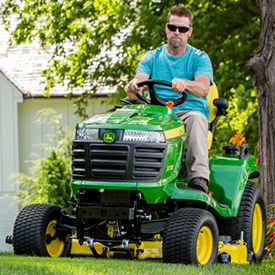 X730 Tractor with 48A Mower Deck
X730 Tractor with 48A Mower Deck
The MulchControl attachment makes mulching more practical for many mowing situations because it not only does an excellent job of mulching but it also allows the mower to be easily converted for times when it is more desirable to side discharge or collect the lawn material. Advantages of mulching grass clippings include:
- A beautiful looking lawn
- Grass clippings not blown onto the operator, driveways, or flower beds
- Less fertilizer use
- Elimination of the effort needed to dispose of clippings
How MulchControl works
 MulchControl baffle open
MulchControl baffle open
 MulchControl baffle closed
MulchControl baffle closed
MulchControl is an innovative, simple design that is easy to use and maintain:
- The MulchControl attachment includes baffles to control the flow of material under the deck.
- The left mower blade area is completely enclosed and optimized for mulching, thus will mulch even when the mower is in the side-discharge mode.
- Baffles around the center and right blades are optimized for mulching when the discharge baffle is closed.
MulchControl handle
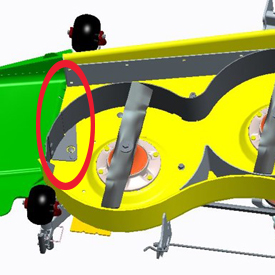 MulchControl baffle closed
MulchControl baffle closed
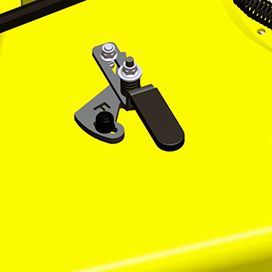 MulchControl handle
MulchControl handle
- The MulchControl handle is located on top of the mower deck and used to open and close the discharge baffle.
- The operator is required to get off of the machine in order to engage or disengage mulch mode.
- Changing from mulching to side discharge or vice versa takes only a few seconds.
MulchControl is well-suited to the following mowing situations:
- Usually mulch, but side-discharge when grass gets too long
- Usually side discharge, but would like to be able to close the chute to control clippings
- Always mulch a main lawn, but often side discharge secondary lawns
- Bag clippings, but want to go farther before emptying bags
MulchControl puts the operator in control of the clippings. Now the operator can have all the benefits of mulching with the ability to easily change to side-discharge or bagging when needed.
MulchControl limitations
While in the side-discharge mode, MulchControl will still mulch about one third of the material. Therefore, the side-discharge mode is essentially a partial-mulch mode. This can be an advantage when side discharging or bagging, as it helps to reduce the amount of material being discharged. Other times this could work as a disadvantage:
- When cutting strong southern grasses, such as Zoysia and Bermuda
- When cutting in wet, high-growth conditions, such as those found in the Pacific Northwest United States
- When optimum bagging and lawn clean-up is desired
Compatibility
MulchControl is a field-installed attachment and compatible with the following tractors:
- 2013 and later X700 Signature Series Tractor (SN 10,001-) 9077M 48-in. (122-cm) Accel Deep Mower Deck
- 2015 and later X700 Signature Series Tractor 9074M 54-in. (137-cm) and 9075M 60-in. (152-cm) HC Mower Deck (SN 030,001-)
Features
Design includes a heavy-duty formed and welded steel frame
 ZTrak™ Z335E shown
ZTrak™ Z335E shown
 ZTrak Z535M shown
ZTrak Z535M shown
ZTrak Mowers are designed around a heavy-duty formed and welded steel frame for strength and reliability.
Large front caster wheels and large rear drive wheels provide several operator benefits:
-
Smoother ride
-
Better slope performance
-
More operator comfort over uneven ground
-
Better traction
The operator platform is roomy and uncluttered for maximum comfort, and the controls are convenient to use:
- Easy to get on and off the mower
- Ample legroom for comfortable operation
- Adjustable motion-control levers for height and position, enabling the operator to stay comfortable while using them
- Color-coded and logically placed controls
Engine is smooth and powerful V-twin design with features for reliability and long life
 25-hp (18.6-kW) engine in vehicle
25-hp (18.6-kW) engine in vehicle
A 25-hp (18.6-kW) V-twin engine provides plenty of power and torque to handle tough mulching, mowing, and bagging conditions:
- V-twin cylinder design gives greater torque, lower vibration, and improved sound quality.
- Engine model M44 Cyclonic™
- Electronic ignition contributes to fast starts.
- Cast-iron cylinder sleeves provide a long-wearing surface for longer engine life.
- Overhead valves allow the engine to breathe easily for excellent power and fuel economy.
Rear engine guard protects the engine and provides additional vehicle strength and integrity.
 Cyclonic air cleaner
Cyclonic air cleaner
 Replaceable air filter
Replaceable air filter
Cyclonic air-management system removes larger particles of dirt before they reach the air filter for reduced filter maintenance and longer engine life:
- Cyclonic design ejects large dirt particles before they make contact with the filter.
- Large, high-quality dry-type paper element air filter thoroughly cleans engine intake air.
- The air filter is easily removed for cleaning or replacement.
 Replaceable oil filter and in-line fuel filter
Replaceable oil filter and in-line fuel filter
Full-pressure lubrication system provides plenty of oil to the engines moving parts to ensure reliable operation and long life:
- Replaceable oil filter keeps the oil cleaner for a longer engine life.
- Extends the time between oil changes
- Full-pressure lubrication is more effective when operating on an incline.
 Engine oil-fill cap and oil-drain hose
Engine oil-fill cap and oil-drain hose
No-tools oil-drain cap with hose and oil filter drip tray are provided for easy, no-mess maintenance.
John Deere recommends the use of fuel stabilizer in gasoline. See] Fuel-Protect for gasoline engines (8 oz [237 mL]) for more information.
Operator station is designed for comfort and convenience
 Operator station (Z535M shown)
Operator station (Z535M shown)
 Color-coded controls are easy to identify
Color-coded controls are easy to identify
The operator station is designed for operator comfort and convenience in operating all controls:
- Excellent visibility forward and to the trim side of the deck makes operation easy and comfortable for the operator.
- Controls are color coded for easy identification.
- Twin-lever motion-control levers adjust, using cut-height pin/socket, for convenience and operator comfort.
- Shock absorbers dampen control movements to give smooth operation.
Comfortable seat
 Comfortable seat (Z525E)
Comfortable seat (Z525E)
 Comfortable seat (Z535M, Z540M)
Comfortable seat (Z535M, Z540M)
 Comfortable seat (Z535R, Z540R)
Comfortable seat (Z535R, Z540R)
Comfortable seats have two suspension springs and no-tools fore-aft seat adjustment that can be used by the operator while seated:
- Z525E – Medium-back, 15-in. (38-cm) seat with adjustable armrests and 3-in. (7.6-cm) fore-aft adjustment
- Z535M – High-back, 18-in. (45.7-cm) seat with adjustable armrests and 3-in. (7.6-cm) fore-aft adjustment
- Z540M – High-back, 18-in. (45.7-cm) seat with adjustable armrests and 3-in. (7.6-cm) fore-aft adjustment
- Z535R – High-back, 21-in. (53.3-cm) seat with adjustable armrests and 4.5-in. (11.4-cm) fore-aft adjustment
- Z540R – High-back, 21-in. (53.3-cm) seat with adjustable armrests and 4.5-in. (11.4-cm) fore-aft adjustment
Seat suspension
 Seat suspension springs
Seat suspension springs
Two steel springs under the seat absorb shocks when traveling over rougher areas to provide a smoother ride.
Cup holder and storage compartment
 Cup holder (Z525E shown)
Cup holder (Z525E shown)
 Open storage compartment
Open storage compartment
Flip-up foot platform
 Flip-up foot platform
Flip-up foot platform
The commercial-style steel footrest flips up to provide easy access for servicing the mower deck:
- Easy to clean grass off the top of the mower
- Provides convenient access to the mower drive
Conveniently located fuel-sight window allows operator to see fuel level
 Easy to view fuel level (fuel-sight window)
Easy to view fuel level (fuel-sight window)
 Easy-to-fill fuel tank
Easy-to-fill fuel tank
A convenient fuel-sight window is located where it is easy for the operator to see:
- Semi-clear material makes seeing how much fuel is in the tank quick and easy.
- Large, 3-in. (7.6-cm) fuel-fill opening reduces the chance of spilling when adding fuel.
- Fuel-fill opening is low and angled to make adding fuel easy.
- Cap is tethered to the fuel tank.
- Less chance of fuel cap getting lost
Serviceability is designed-in for convenience
 Service interval decal (Z300 Series shown)
Service interval decal (Z300 Series shown)
 Service interval decal (Z500 Series shown)
Service interval decal (Z500 Series shown)
A convenient service interval decal provides basic maintenance information. It provides a quick-reference for keeping recommended service up to date.
Mower deck access
 Footrest easily removed for access to mower (Z335E shown)
Footrest easily removed for access to mower (Z335E shown)
 Footrest removal bolt and hand grip (Z335E shown)
Footrest removal bolt and hand grip (Z335E shown)
The footrest area is hinged and easily raised for service to mower deck:
- It is necessary to remove just one bolt that can be conveniently removed with the lift-height pin.
-
Easy to clean grass off the top of the mower
-
Provides convenient access to the mower drive
 Loosening bolt to remove platform for access to mower deck
Loosening bolt to remove platform for access to mower deck
 Footrest opens for access to mower deck
Footrest opens for access to mower deck
Engine service
 Z335E engine
Z335E engine
 Z335E engine oil and fuel filters shown
Z335E engine oil and fuel filters shown
 Z535M and Z535R engine
Z535M and Z535R engine
 Z540M and Z540R engine
Z540M and Z540R engine
 Easy-to-access oil filter, fill/check oil tube, and oil drain
Easy-to-access oil filter, fill/check oil tube, and oil drain
The engines are easy to service, including changing the oil and the oil filter and servicing the air filter.
 Accel Deep Mower Deck
Accel Deep Mower Deck
 Tie-down locations
Tie-down locations
Accel Deep™ Mower Decks have several features that make them easy to service:
- Flat-top design minimizes places for debris to collect.
- Spring-loaded, flip-up belt guards make removing debris easy.
- Provision is provided for a standard, 3/8-in. (9.5-mm) ratchet wrench to be used for releasing belt tension when removing the drive belt.
Tie-down locations are provided for convenience and safety when trailering the machine.
The 48-in. (122-cm) Accel Deep™ (48A) Mower Deck cuts clean and is versatile
 Z535M ZTrak™ Mower with Accel Deep 48A Mower
Z535M ZTrak™ Mower with Accel Deep 48A Mower
 Accel Deep 48A Mower
Accel Deep 48A Mower
The 48-in. (122-cm) Accel Deep Mower Deck is a stamped-steel, deep, flat-top design that delivers excellent cut quality, productivity, cleanliness, durability, and versatility. Optimal performance and dispersion of clippings is provided, even at faster mowing speeds:
- 4.5-in. (11.4-cm) deep throughout the entire deck shell for optimum mowing, mulching, and bagging performance
- Optional MulchControl™ attachment provides superior mulching performance and versatility.
- Stamped-steel design eliminates sharp edges and corners where material can build up and diminish mowing performance
- Mower deck is suspended from the vehicle for a smooth and level cut
- Adjustable mower wheels, positioned just above ground level, help smooth out the mowing job
Excellent cut quality
 48A Mower top (similar mower from X700 Series Tractor shown)
48A Mower top (similar mower from X700 Series Tractor shown)
 48A Mower underside (similar mower from X700 Series Tractor shown)
48A Mower underside (similar mower from X700 Series Tractor shown)
Deep mower-deck stamping gives excellent cut quality. It allows the cut and suspended material room to exit the deck without getting recut:
- Reducing the amount of re-cutting enables more power to be used to cut incoming grass, which greatly improves mower capacity.
- Helps maintain excellent cut quality at faster mowing speeds
- Clean flow of material out of discharge area prevents cut material from interfering with cutting the incoming grass, making it possible for the blades to cut incoming material cleanly.
- Even in mulching mode, cut evenness is improved compared to other designs because the additional depth allows for continuous circulation, optimal re-cutting, and an even distribution of clippings.
Productivity - getting the job done fast
 Right side of Accel Deep 48A Mower Deck
Right side of Accel Deep 48A Mower Deck
Deep mower-deck stamping gives high productivity, which gets the job done fast. It allows the cut and suspended material room to exit the deck quickly, reducing the amount of recutting so more power is available to process incoming grass:
- Greatly improves mowers capacity to maintain excellent mowing performance in difficult mowing conditions and at higher speeds
Large discharge opening is both high and wide to handle more material:
- Gives a smooth, even discharge of clippings at all mowing speeds
- Reduces the chance of plugging, especially important when operating in wet, thick, or dense grass and when bagging
- The 48A Power Flow™ blower has an inlet housing with over 50 percent greater area than the 48X Power Flow blower used on previous machines.
Cleanliness - for the mower and the operator
 Accel Deep 48A Mower Deck
Accel Deep 48A Mower Deck
 Accel Deep 48A Mower Deck
Accel Deep 48A Mower Deck
The flat-top shape of the deck stamping is optimal for keeping itself and the operator clean:
- There are few places to catch and hold material on top and underneath the deck.
- Top of deck stays cleaner, reducing time and effort needed for cleaning and service
- Underside of deck is self-cleaning to maintain optimum performance without buildup of material to interfere with the flow of air and clippings
- Less need to clean and remove buildup of material from underside deck
- The depth of the Accel Deep Mower Deck minimizes the amount of material that escapes from the front of the deck
- Limited amount of material to drift onto the operator and mower deck
- Even for material discharged out the chute, less recutting results in larger pieces that are less likely to end up on the operator
- Mulching prevents the discharge of material completely and the MulchControl attachment makes mulching a practical solution for most mowing situations.
Cleaning a mower deck, both top and bottom, is one of the most frequent maintenance activities:
- The flat-top design reduces places for material to build up and makes material that does collect easy to remove.
 Mower wash port
Mower wash port
 Mower wash port with hose connector
Mower wash port with hose connector
A wash port is provided to make cleaning the underside of the mower deck easy.
- Hose connector is included with the mower deck.
Superior durability is designed in
 Spindle pocket
Spindle pocket
 Mower wheels are double captured
Mower wheels are double captured
The 48A Mower Deck has strong spindle pockets, to keep the blades aligned, even after years of tough service:
- Ribs in the deck shell add strength where it is needed.
- The 48A has a 23 percent heavier overall weight than the Edge™ Xtra 48-in. (122-cm) Mower Deck used on previous machines.
Mower wheels are double-captured:
- Provides greater strength and durability for longer, trouble-free life.
- Single-bolt adjustment makes setting wheels to the correct height for the cutting height quick and easy.
Low-tension belt-drive design reduces the side load on engine lower bearings and mower deck bearings for longer life.
The 48A Mower Deck features a 5/8-in. (16-mm) diameter solid-steel rod side bumper that provides extra strength and protection.
Dual-stage E-coat and powder-paint coatings provide extra protection from rust.
Versatility - easy to change between side discharge, mulch, and bagging modes
The 48A Mower is designed for maximum versatility, providing the greatest ease in changing from one mower discharge mode to another:
- With the optional MulchControl attachment installed (along with the special mulching blades), changing from side-discharge to mulching or vice versa is done with the simple flip of a lever.
- The Power Flow rear bagger can be used with the MulchControl attachment and blades installed - by simply placing the MulchControl lever in the side-discharge position.
MulchControl option
The MulchControl attachment for the 48A Mower Deck makes mulching more practical for many mowing situations because it not only does an excellent job of mulching but it also allows the mower to be easily converted for times when it is more desirable to side discharge or collect the lawn material. Advantages of mulching grass clippings include:
- A beautiful looking lawn
- Grass clippings not blown onto the operator, driveways, or flower beds
- Less fertilizer use
- Elimination of the effort needed to dispose of clippings
How MulchControl works
 MulchControl baffle open (similar mower from X700 Series Tractor shown)
MulchControl baffle open (similar mower from X700 Series Tractor shown)
 MulchControl baffle closed (similar mower from X700 Series Tractor shown)
MulchControl baffle closed (similar mower from X700 Series Tractor shown)
MulchControl is an innovative, simple design that is easy to use and maintain:
- The MulchControl attachment includes baffles to control the flow of material under the deck.
- The MulchControl baffle, or divider, between the left and middle spindles is about half way down. The height is designed to balance the mulching and side-discharge modes.
- When the MulchControl baffle is open, the divider between the left and middle spindles passes a portion of the material to the discharge opening, along with the material from the middle and right spindle areas.
- When the MulchControl baffle is closed, the material stays within the deck and gets chopped into mulch and deposited in the turf.
 MulchControl baffle closed
MulchControl baffle closed
 MulchControl handle
MulchControl handle
- The MulchControl handle is located on top of the mower deck and used to open and close the discharge baffle.
- The operator is required to get off of the machine in order to engage or disengage mulch mode.
- Changing from mulching to side discharge or vice versa takes only a few seconds.
MulchControl is well-suited to the following mowing situations:
- Usually mulch, but side discharge when grass gets too long
- Usually side-discharge, but would like to be able to close the chute to control clippings
- Always mulch a main lawn, but often side discharge secondary lawns
- Bag clippings, but want to go farther before emptying bags
MulchControl puts the operator in control of the clippings. Now the operator can have all the benefits of mulching with the ability to easily change to side discharge or bagging when needed.
While in the side-discharge mode, MulchControl will still mulch about one-third of the material. Therefore, the side-discharge mode is essentially a partial-mulch mode. This can be an advantage when side discharging or bagging, as it helps to reduce the amount of material being discharged. Other times this could work as a disadvantage:
- When cutting strong southern grasses, such as Zoysia and Bermuda
- When cutting in wet, high-growth conditions, such as those found in the Pacific Northwest United States
- When optimum bagging and lawn clean-up is desired
6.5-bu (230-L) Power Flow rear bagger (rear bagger not available for ZTrak Z355E or Z355R)
 Optional rear bagger
Optional rear bagger
 Power Flow blower
Power Flow blower
An optional 6.5-bu (230-L) Power Flow Rear Bagger material collection system (MCS) is available. It provides an efficient means of collecting grass clippings and leaves:
- The Power Flow blower and chute are easy to install. The Power Flow blower swings out for easy cleanout and cleanup.
- The hopper design provides modern styling, great bagging performance, cleaner operation, and easy-to-empty bags:
- 6.5-bu (230-L) capacity
- Easy-to-attach Power Flow blower (ordered separately)
- Easy-to-attach chute (ordered separately)
- Air exhaust duct
- Convenient spring-latch
- Airflow fill indicator
- Quik-Tatch mounting
- Sealed hopper top
- Loose-knit bags available
The 54-in. (138-cm) Accel Deep™ (54A) Mower Deck cuts clean and is versatile
 Z525E ZTrak™ Mower with Accel Deep 54A Mower
Z525E ZTrak™ Mower with Accel Deep 54A Mower
 Accel Deep 54A Mower
Accel Deep 54A Mower
The 54-in. (138-cm) Accel Deep Mower Deck is a stamped-steel, deep, flat-top design that delivers excellent cut quality, productivity, cleanliness, durability, and versatility. Optimal performance and dispersion of clippings is provided, even at faster mowing speeds:
- 4.5-in. (11.4-cm) deep throughout the entire deck shell for optimum mowing, mulching, and bagging performance
- Optional MulchControl™ attachment provides superior mulching performance and versatility.
- Stamped-steel design eliminates sharp edges and corners where material can build up and diminish mowing performance
- Mower deck is suspended from the vehicle for a smooth and level cut
- Adjustable mower wheels, positioned just above ground level, help smooth out the mowing job
Excellent cut quality
 54A Mower top (similar mower from X500 Series Tractor shown)
54A Mower top (similar mower from X500 Series Tractor shown)
 54A Mower underside (similar mower from X500 Series Tractor shown)
54A Mower underside (similar mower from X500 Series Tractor shown)
Deep mower-deck stamping gives excellent cut quality. It allows the cut and suspended material room to exit the deck without getting recut:
- Reducing the amount of recutting enables more power to be used to cut incoming grass, which greatly improves mower capacity.
- Helps maintain excellent cut quality at faster mowing speeds
- Clean flow of material out of discharge area prevents cut material from interfering with cutting the incoming grass, making it possible for the blades to cut incoming material cleanly.
- Even in mulching mode, cut evenness is improved compared to other designs because the additional depth allows for continuous circulation, optimal recutting, and an even distribution of clippings.
Productivity - getting the job done fast
 Right side of Accel Deep 54A Mower Deck
Right side of Accel Deep 54A Mower Deck
Deep mower-deck stamping gives high productivity, which gets the job done fast. It allows the cut and suspended material room to exit the deck quickly, reducing the amount of re-cutting so more power is available to process incoming grass:
- Greatly improves mowers capacity to maintain excellent mowing performance in difficult mowing conditions and at higher speeds
Large discharge opening is both high and wide to handle more material:
- Gives a smooth, even discharge of clippings at all mowing speeds
- Reduces the chance of plugging, especially important when operating in wet, thick, or dense grass and when bagging
- The 54A Power Flow™ blower has an inlet housing with over 50 percent greater area than the 48X Power Flow blower used on previous machines.
Cleanliness - for the mower and the operator
 Accel Deep 54A Mower Deck
Accel Deep 54A Mower Deck
 Accel Deep 54A Mower Deck
Accel Deep 54A Mower Deck
The flat-top shape of the deck stamping is optimal for keeping itself and the operator clean:
- There are few places to catch and hold material on top and underneath the deck.
- Top of deck stays cleaner, reducing time and effort needed for cleaning and service
- Underside of deck is self-cleaning to maintain optimum performance without buildup of material to interfere with the flow of air and clippings
- Less need to clean and remove build-up of material from underside deck
- The depth of the Accel Deep Mower Deck minimizes the amount of material that escapes from the front of the deck
- Limited amount of material to drift onto the operator and mower deck
- Even for material discharged out the chute, less re-cutting results in larger pieces that are less likely to end up on the operator
- Mulching prevents the discharge of material completely and the MulchControl attachment makes mulching a practical solution for most mowing situations.
Cleaning a mower deck, both top and bottom, is one of the most frequent maintenance activities:
- The flat-top design reduces places for material to build up and makes material that does collect easy to remove.
 Mower wash port
Mower wash port
 Mower wash port with hose connector
Mower wash port with hose connector
A wash port is provided to make cleaning the underside of the mower deck easy.
- Hose connector is included with the mower deck.
Superior durability is designed in
 Spindle pocket
Spindle pocket
 Mower wheels are double captured
Mower wheels are double captured
The 54A Mower Deck has strong spindle pockets, to keep the blades aligned, even after years of tough service:
- Ribs in the deck shell add strength where it is needed.
Mower wheels are double captured:
- Provides greater strength and durability for longer, trouble-free life.
- Single-bolt adjustment makes setting wheels to the correct height for the cutting height quick and easy.
Low-tension belt-drive design reduces the side load on engine lower bearings and mower deck bearings for longer life.
The 54A Mower Deck features a 5/8-in. (16-mm) diameter solid-steel rod side bumper that provides extra strength and protection.
Dual-stage E-coat and powder-paint coatings provide extra protection from rust.
Versatility - easy to change between side discharge, mulch, and bagging modes
The 54A Mower is designed for maximum versatility, providing the greatest ease in changing from one mower discharge mode to another:
- With the optional MulchControl attachment installed (along with the special mulching blades), changing from side discharge to mulching or vice versa is done with the simple flip of a lever.
- The Power Flow rear bagger can be used with the MulchControl attachment and blades installed - by simply placing the MulchControl lever in the side discharge position.
MulchControl option
The MulchControl attachment for the 54A Mower Deck makes mulching more practical for many mowing situations because it not only does an excellent job of mulching but it also allows the mower to be easily converted for times when it is more desirable to side discharge or collect the lawn material. Advantages of mulching grass clippings include:
- A beautiful looking lawn
- Grass clippings not blown onto the operator, driveways, or flower beds
- Less fertilizer use
- Elimination of the effort needed to dispose of clippings
How MulchControl works
 MulchControl baffle open
MulchControl baffle open
 MulchControl baffle closed
MulchControl baffle closed
MulchControl is an innovative, simple design that is easy to use and maintain:
- The MulchControl attachment includes baffles to control the flow of material under the deck.
The MulchControl baffle, or divider, between the left and middle spindles is about half way down. The height is designed to balance the mulching and side-discharge modes.
When the MulchControl baffle is open, the divider between the left and middle spindles passes a portion of the material to the discharge opening, along with the material from the middle and right spindle areas.
- When the MulchControl baffle is closed, the material stays within the deck and gets chopped into mulch and deposited in the turf.
 MulchControl baffle closed
MulchControl baffle closed
 MulchControl handle
MulchControl handle
- The MulchControl handle is located on top of the mower deck and used to open and close the discharge baffle.
- The operator is required to get off of the machine in order to engage or disengage mulch mode.
- Changing from mulching to side discharge or vice versa takes only a few seconds.
MulchControl is well-suited to the following mowing situations:
- Usually mulch, but side discharge when grass gets too long
- Usually side-discharge, but would like to be able to close the chute to control clippings
- Always mulch a main lawn, but often side discharge secondary lawns
- Bag clippings, but want to go farther before emptying bags
MulchControl puts the operator in control of the clippings. Now the operator can have all the benefits of mulching with the ability to easily change to side discharge or bagging when needed.
While in the side-discharge mode, MulchControl will still mulch about one third of the material. Therefore, the side-discharge mode is essentially a partial-mulch mode. This can be an advantage when side discharging or bagging, as it helps to reduce the amount of material being discharged. Other times this could work as a disadvantage:
- When cutting strong southern grasses, such as Zoysia and Bermuda
- When cutting in wet, high-growth conditions, such as those found in the Pacific Northwest United States
- When optimum bagging and lawn clean-up is desired
6.5-bu (230-L) Power Flow Rear Bagger (rear bagger not available for ZTrak Z375R)
 Optional rear bagger
Optional rear bagger
 Power Flow blower
Power Flow blower
An optional 6.5-bu (230-L) rear bagger material collection system (MCS) is available. It provides an efficient means of collecting grass clippings and leaves:
- The Power Flow blower and chute are easy to install. The Power Flow blower swings out for easy cleanout and cleanup.
- The hopper design provides modern styling, great bagging performance, cleaner operation, and easy-to-empty bags:
- 6.5-bu (230-L) capacity
- Easy-to-attach Power Flow blower (ordered separately)
- Easy-to-attach chute (ordered separately)
- Air exhaust duct
- Convenient spring-latch
- Airflow fill indicator
- Quik-Tatch mounting
- Sealed hopper top
- Loose-knit bags available
- Hopper kit comes with ballast bracket and (4) weights
The Edge™ Cutting System 62-in. (157-cm) Mower Deck can take on the biggest mowing jobs
 Z540M with 62-in. (157-cm) Edge Mower Deck
Z540M with 62-in. (157-cm) Edge Mower Deck
 62-in. (157-cm) Edge Mower Deck on Z540M
62-in. (157-cm) Edge Mower Deck on Z540M
The 62-in. (157-cm) Mower is a deep-deck design:
-
Mower can side-discharge or mulch.
- Durable plastic deflector spreads grass clippings evenly across the lawn, is hinged, and can be raised to minimize the storage space required.
Features of the 62-in. (157-cm) Mower Deck include:
- Deep-deck design does a superior job of lifting grass for a clean, even cut.
- Smooth underside of the mower prevents grass buildup and evenly disperses grass clippings.
- Mower deck is stamped from heavy, 10-gauge, 0.135-in. (3.4-mm) steel for superior durability and long life.
- Rolled outer edge of the deck provides extra strength and protection.
- Dual-stage E-coat and powder-paint coatings provide extra protection from rust.
 Mower wash port
Mower wash port
 Mower wash port with hose connector
Mower wash port with hose connector
A wash port is provided to make cleaning the underside of the mower deck easy:
-
Hose connector is included with the mower deck.
 Mulching attachment shown on X500 Tractor mower
Mulching attachment shown on X500 Tractor mower

An optional mulching attachment is available:
- This is a high-performance mulching attachment that includes a mulch plug and special mulching blades.
- The special mulching blades included can also be used for side discharging, though the overall cut quality may decline slightly.
Features
Design includes a heavy-duty formed and welded steel frame
 ZTrak™ Z335E shown
ZTrak™ Z335E shown
 ZTrak Z535M shown
ZTrak Z535M shown
ZTrak Mowers are designed around a heavy-duty formed and welded steel frame for strength and reliability.
Large front caster wheels and large rear drive wheels provide several operator benefits:
-
Smoother ride
-
Better slope performance
-
More operator comfort over uneven ground
-
Better traction
The operator platform is roomy and uncluttered for maximum comfort, and the controls are convenient to use:
- Easy to get on and off the mower
- Ample legroom for comfortable operation
- Adjustable motion-control levers for height and position, enabling the operator to stay comfortable while using them
- Color-coded and logically placed controls
Engine is smooth and powerful V-twin design
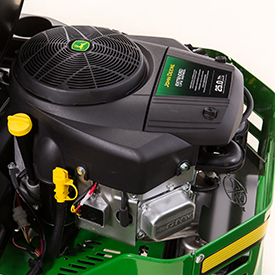 Engine, left rear view
Engine, left rear view
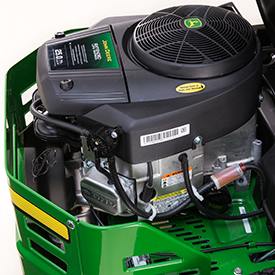 Engine, right rear view
Engine, right rear view
A V-twin engine with 44.2-cu in. (724-cc) displacement provides plenty of power and torque to handle tough mulching, mowing, and bagging conditions:
- V-twin cylinder design for greater torque, lower vibration, and improved sound quality
- Engine model M44 ELS
- Electronic ignition for fast starts
- Cast-iron sleeves for longer engine life
- Overhead valves for excellent power and fuel economy
- Spin-on oil filter with pressure lubrication for keeping the oil cleaner for long engine life and extended time between oil changes; pressure lubrication is also more effective when operating the tractor on an incline
- Easy access to the no-tools oil drain valve for oil changes
- Rear engine guard for protecting the engine and providing additional strength and integrity
The Z375R and Z525E engines have extended life series (ELS) features for enhanced performance and longer life.
 Engine oil check/fill tube and oil-drain tube
Engine oil check/fill tube and oil-drain tube
 Replaceable fuel filter and oil filter
Replaceable fuel filter and oil filter
Replaceable fuel filter and oil filter are easy to access and change to minimize service time and cost.
John Deere recommends the use of fuel stabilizer in gasoline. See Fuel-Protect for gasoline engines (8 oz [237 mL]) for more information
Full-featured engine is more reliable and lasts longer
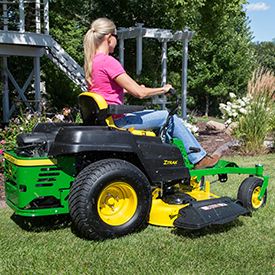 Z525E with 54-in. (137-cm) Mower Deck shown
Z525E with 54-in. (137-cm) Mower Deck shown
The Z375R and the Z525E have a full-featured engine with extended life series (ELS) features that is engineered to deliver world-class endurance and power. A step above the competition, it is designed to be more dependable and longer lasting, saving time and money over the long run.
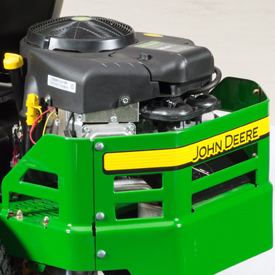 22-hp (16.4-kW) engine (left rear view shown)
22-hp (16.4-kW) engine (left rear view shown)
 22-hp (16.4-kW) engine (right rear view shown)
22-hp (16.4-kW) engine (right rear view shown)
Built to exceed demanding needs by incorporating premium features and innovative designs:
- Overhead valve (OHV) design for cooler operation and longer valve life
- Contains an advanced debris management system that directs cooling air through the rotating screen to the air cleaner compartment, where large debris is pre-filtered through ejector slots
- Keeps unfiltered air out of the engine through a large, dual-sealed, premium oval-shaped cartridge-style filter
- Ensures maximum protection for extended engine life with the premium air cleaner, a pleated paper filter with a foam precleaner
- Captures fine particles for maximum protection and extended maintenance
- Provides maximum protection with full-pressure lubrication system
- Pumps oil by a mechanical gerotor-style pump to all critical engine components
- Enhances the system through a premium automotive-style spin-on oil filter, which removes over 95 percent of oil contaminates
- A premium bearing package for improved durability; includes a super-finished crank pin bearing with a 50 percent smoother surface to increase load capacity by 35 percent
- Uses a premium DU Teflon®-coated bearing
- Helps resist wear and increases durability through self-lubricating bronze bearing
- Wear-resistant chrome-plated valve stems for long-life valves
- 44 percent smoother for longer life
- Cast-iron cylinder sleeve for extended life
- Dependable float-feed type carburetor with integral fuel pump
- High-capacity fuel filter for dependable operation
- 30 micron filter with 55 percent more filter area than standard filters
- Maintenance-free electronic ignition for quick, dependable starts
- Platinum spark plugs for extended life
Teflon is a trademark of E.I. du Pont de Nemours and Company or its affiliates.
Operator station is designed for comfort and convenience
 Operator station (Z535M shown)
Operator station (Z535M shown)
 Color-coded controls are easy to identify
Color-coded controls are easy to identify
The operator station is designed for operator comfort and convenience in operating all controls:
- Excellent visibility forward and to the trim side of the deck makes operation easy and comfortable for the operator.
- Controls are color coded for easy identification.
- Twin-lever motion-control levers adjust, using cut-height pin/socket, for convenience and operator comfort.
- Shock absorbers dampen control movements to give smooth operation.
Comfortable seat
 Comfortable seat (Z525E)
Comfortable seat (Z525E)
 Comfortable seat (Z535M, Z540M)
Comfortable seat (Z535M, Z540M)
 Comfortable seat (Z535R, Z540R)
Comfortable seat (Z535R, Z540R)
Comfortable seats have two suspension springs and no-tools fore-aft seat adjustment that can be used by the operator while seated:
- Z525E – Medium-back, 15-in. (38-cm) seat with adjustable armrests and 3-in. (7.6-cm) fore-aft adjustment
- Z535M – High-back, 18-in. (45.7-cm) seat with adjustable armrests and 3-in. (7.6-cm) fore-aft adjustment
- Z540M – High-back, 18-in. (45.7-cm) seat with adjustable armrests and 3-in. (7.6-cm) fore-aft adjustment
- Z535R – High-back, 21-in. (53.3-cm) seat with adjustable armrests and 4.5-in. (11.4-cm) fore-aft adjustment
- Z540R – High-back, 21-in. (53.3-cm) seat with adjustable armrests and 4.5-in. (11.4-cm) fore-aft adjustment
Seat suspension
 Seat suspension springs
Seat suspension springs
Two steel springs under the seat absorb shocks when traveling over rougher areas to provide a smoother ride.
Cup holder and storage compartment
 Cup holder (Z525E shown)
Cup holder (Z525E shown)
 Open storage compartment
Open storage compartment
Flip-up foot platform
 Flip-up foot platform
Flip-up foot platform
The commercial-style steel footrest flips up to provide easy access for servicing the mower deck:
- Easy to clean grass off the top of the mower
- Provides convenient access to the mower drive
Instruments and controls are convenient and easy to use
Motion-control levers
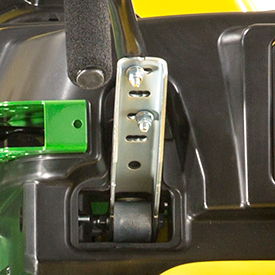 Adjustable motion-control levers
Adjustable motion-control levers
The motion-control levers can be adjusted to three different height settings and fifteen different fore-aft settings:
- Increased operator comfort
- Adjustable for most precise control of the machine
- Adjustment of the control lever can be done with the cut-height pin
 Shock absorber for motion-control levers
Shock absorber for motion-control levers
A standard shock absorber for the motion-control levers makes maneuvering ZTrak™ Mowers easy and comfortable:
- Shock absorber modulates the movement of control levers for smoother operation.
- Operator can smoothly and precisely control the machine.
Tracking adjustment
 Cut-height pin doubles as tracking adjustment tool
Cut-height pin doubles as tracking adjustment tool
 Adjusting tracking with cut-height pin
Adjusting tracking with cut-height pin
On-board tracking adjustment from the operator seat is quick and easy. The cut-height pin includes a 13-mm wrench and doubles as a convenient tool for adjusting tracking and the motion-control lever position:
-
The red arrow indicates the socket included on the cut-height pin that can be used for the operator to use when making a tracking adjustment.
Control panel
 Control panel (Z525E shown)
Control panel (Z525E shown)
The operator control panel is conveniently located and easy to use.
The following instruments and controls are included:
- Hourmeter
- Ignition switch
- Power take-off (PTO) control
- Engine speed/choke control
- A choke position is built into the engine speed control (525E, Z535M).
- A separate lever is provided for operating the choke (Z540M)
Park brake
 Park brake
Park brake
The park brake is conveniently located:
- Large lever is easy to use.
- Park brake effectively holds the machine in the parked position.
- Park brake must be engaged (in the upper position) to start the engine.
- Once the engine is started, the park brake must be disengaged before operating the motion-control levers.
Mower deck lift/cut-height adjustment
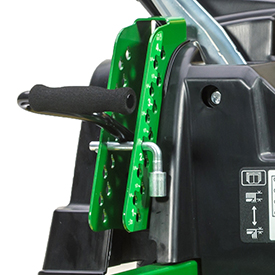 Mower deck lift/cut-height adjustment
Mower deck lift/cut-height adjustment
- Mower deck cutting height adjusts from 1 in. (2.5 cm) to 4 in. (10.2 cm) in 0.25-in. (0.64-cm) increments for excellent cut quality and performance.
- Mower-deck adjustment has built-in memory so the operator can easily return to the desired cutting height after raising the deck.
Serviceability is designed-in for convenience
 Service interval decal (Z300 Series shown)
Service interval decal (Z300 Series shown)
 Service interval decal (Z500 Series shown)
Service interval decal (Z500 Series shown)
A convenient service interval decal provides basic maintenance information. It provides a quick-reference for keeping recommended service up to date.
Mower deck access
 Footrest easily removed for access to mower (Z335E shown)
Footrest easily removed for access to mower (Z335E shown)
 Footrest removal bolt and hand grip (Z335E shown)
Footrest removal bolt and hand grip (Z335E shown)
The footrest area is hinged and easily raised for service to mower deck:
- It is necessary to remove just one bolt that can be conveniently removed with the lift-height pin.
-
Easy to clean grass off the top of the mower
-
Provides convenient access to the mower drive
 Loosening bolt to remove platform for access to mower deck
Loosening bolt to remove platform for access to mower deck
 Footrest opens for access to mower deck
Footrest opens for access to mower deck
Engine service
 Z335E engine
Z335E engine
 Z335E engine oil and fuel filters shown
Z335E engine oil and fuel filters shown
 Z535M and Z535R engine
Z535M and Z535R engine
 Z540M and Z540R engine
Z540M and Z540R engine
 Easy-to-access oil filter, fill/check oil tube, and oil drain
Easy-to-access oil filter, fill/check oil tube, and oil drain
The engines are easy to service, including changing the oil and the oil filter and servicing the air filter.
 Accel Deep Mower Deck
Accel Deep Mower Deck
 Tie-down locations
Tie-down locations
Accel Deep™ Mower Decks have several features that make them easy to service:
- Flat-top design minimizes places for debris to collect.
- Spring-loaded, flip-up belt guards make removing debris easy.
- Provision is provided for a standard, 3/8-in. (9.5-mm) ratchet wrench to be used for releasing belt tension when removing the drive belt.
Tie-down locations are provided for convenience and safety when trailering the machine.
The 48-in. (122-cm) Accel Deep™ (48A) Mower Deck cuts clean and is versatile
 Z535M ZTrak™ Mower with Accel Deep 48A Mower
Z535M ZTrak™ Mower with Accel Deep 48A Mower
 Accel Deep 48A Mower
Accel Deep 48A Mower
The 48-in. (122-cm) Accel Deep Mower Deck is a stamped-steel, deep, flat-top design that delivers excellent cut quality, productivity, cleanliness, durability, and versatility. Optimal performance and dispersion of clippings is provided, even at faster mowing speeds:
- 4.5-in. (11.4-cm) deep throughout the entire deck shell for optimum mowing, mulching, and bagging performance
- Optional MulchControl™ attachment provides superior mulching performance and versatility.
- Stamped-steel design eliminates sharp edges and corners where material can build up and diminish mowing performance
- Mower deck is suspended from the vehicle for a smooth and level cut
- Adjustable mower wheels, positioned just above ground level, help smooth out the mowing job
Excellent cut quality
 48A Mower top (similar mower from X700 Series Tractor shown)
48A Mower top (similar mower from X700 Series Tractor shown)
 48A Mower underside (similar mower from X700 Series Tractor shown)
48A Mower underside (similar mower from X700 Series Tractor shown)
Deep mower-deck stamping gives excellent cut quality. It allows the cut and suspended material room to exit the deck without getting recut:
- Reducing the amount of re-cutting enables more power to be used to cut incoming grass, which greatly improves mower capacity.
- Helps maintain excellent cut quality at faster mowing speeds
- Clean flow of material out of discharge area prevents cut material from interfering with cutting the incoming grass, making it possible for the blades to cut incoming material cleanly.
- Even in mulching mode, cut evenness is improved compared to other designs because the additional depth allows for continuous circulation, optimal re-cutting, and an even distribution of clippings.
Productivity - getting the job done fast
 Right side of Accel Deep 48A Mower Deck
Right side of Accel Deep 48A Mower Deck
Deep mower-deck stamping gives high productivity, which gets the job done fast. It allows the cut and suspended material room to exit the deck quickly, reducing the amount of recutting so more power is available to process incoming grass:
- Greatly improves mowers capacity to maintain excellent mowing performance in difficult mowing conditions and at higher speeds
Large discharge opening is both high and wide to handle more material:
- Gives a smooth, even discharge of clippings at all mowing speeds
- Reduces the chance of plugging, especially important when operating in wet, thick, or dense grass and when bagging
- The 48A Power Flow™ blower has an inlet housing with over 50 percent greater area than the 48X Power Flow blower used on previous machines.
Cleanliness - for the mower and the operator
 Accel Deep 48A Mower Deck
Accel Deep 48A Mower Deck
 Accel Deep 48A Mower Deck
Accel Deep 48A Mower Deck
The flat-top shape of the deck stamping is optimal for keeping itself and the operator clean:
- There are few places to catch and hold material on top and underneath the deck.
- Top of deck stays cleaner, reducing time and effort needed for cleaning and service
- Underside of deck is self-cleaning to maintain optimum performance without buildup of material to interfere with the flow of air and clippings
- Less need to clean and remove buildup of material from underside deck
- The depth of the Accel Deep Mower Deck minimizes the amount of material that escapes from the front of the deck
- Limited amount of material to drift onto the operator and mower deck
- Even for material discharged out the chute, less recutting results in larger pieces that are less likely to end up on the operator
- Mulching prevents the discharge of material completely and the MulchControl attachment makes mulching a practical solution for most mowing situations.
Cleaning a mower deck, both top and bottom, is one of the most frequent maintenance activities:
- The flat-top design reduces places for material to build up and makes material that does collect easy to remove.
 Mower wash port
Mower wash port
 Mower wash port with hose connector
Mower wash port with hose connector
A wash port is provided to make cleaning the underside of the mower deck easy.
- Hose connector is included with the mower deck.
Superior durability is designed in
 Spindle pocket
Spindle pocket
 Mower wheels are double captured
Mower wheels are double captured
The 48A Mower Deck has strong spindle pockets, to keep the blades aligned, even after years of tough service:
- Ribs in the deck shell add strength where it is needed.
- The 48A has a 23 percent heavier overall weight than the Edge™ Xtra 48-in. (122-cm) Mower Deck used on previous machines.
Mower wheels are double-captured:
- Provides greater strength and durability for longer, trouble-free life.
- Single-bolt adjustment makes setting wheels to the correct height for the cutting height quick and easy.
Low-tension belt-drive design reduces the side load on engine lower bearings and mower deck bearings for longer life.
The 48A Mower Deck features a 5/8-in. (16-mm) diameter solid-steel rod side bumper that provides extra strength and protection.
Dual-stage E-coat and powder-paint coatings provide extra protection from rust.
Versatility - easy to change between side discharge, mulch, and bagging modes
The 48A Mower is designed for maximum versatility, providing the greatest ease in changing from one mower discharge mode to another:
- With the optional MulchControl attachment installed (along with the special mulching blades), changing from side-discharge to mulching or vice versa is done with the simple flip of a lever.
- The Power Flow rear bagger can be used with the MulchControl attachment and blades installed - by simply placing the MulchControl lever in the side-discharge position.
MulchControl option
The MulchControl attachment for the 48A Mower Deck makes mulching more practical for many mowing situations because it not only does an excellent job of mulching but it also allows the mower to be easily converted for times when it is more desirable to side discharge or collect the lawn material. Advantages of mulching grass clippings include:
- A beautiful looking lawn
- Grass clippings not blown onto the operator, driveways, or flower beds
- Less fertilizer use
- Elimination of the effort needed to dispose of clippings
How MulchControl works
 MulchControl baffle open (similar mower from X700 Series Tractor shown)
MulchControl baffle open (similar mower from X700 Series Tractor shown)
 MulchControl baffle closed (similar mower from X700 Series Tractor shown)
MulchControl baffle closed (similar mower from X700 Series Tractor shown)
MulchControl is an innovative, simple design that is easy to use and maintain:
- The MulchControl attachment includes baffles to control the flow of material under the deck.
- The MulchControl baffle, or divider, between the left and middle spindles is about half way down. The height is designed to balance the mulching and side-discharge modes.
- When the MulchControl baffle is open, the divider between the left and middle spindles passes a portion of the material to the discharge opening, along with the material from the middle and right spindle areas.
- When the MulchControl baffle is closed, the material stays within the deck and gets chopped into mulch and deposited in the turf.
 MulchControl baffle closed
MulchControl baffle closed
 MulchControl handle
MulchControl handle
- The MulchControl handle is located on top of the mower deck and used to open and close the discharge baffle.
- The operator is required to get off of the machine in order to engage or disengage mulch mode.
- Changing from mulching to side discharge or vice versa takes only a few seconds.
MulchControl is well-suited to the following mowing situations:
- Usually mulch, but side discharge when grass gets too long
- Usually side-discharge, but would like to be able to close the chute to control clippings
- Always mulch a main lawn, but often side discharge secondary lawns
- Bag clippings, but want to go farther before emptying bags
MulchControl puts the operator in control of the clippings. Now the operator can have all the benefits of mulching with the ability to easily change to side discharge or bagging when needed.
While in the side-discharge mode, MulchControl will still mulch about one-third of the material. Therefore, the side-discharge mode is essentially a partial-mulch mode. This can be an advantage when side discharging or bagging, as it helps to reduce the amount of material being discharged. Other times this could work as a disadvantage:
- When cutting strong southern grasses, such as Zoysia and Bermuda
- When cutting in wet, high-growth conditions, such as those found in the Pacific Northwest United States
- When optimum bagging and lawn clean-up is desired
6.5-bu (230-L) Power Flow rear bagger (rear bagger not available for ZTrak Z355E or Z355R)
 Optional rear bagger
Optional rear bagger
 Power Flow blower
Power Flow blower
An optional 6.5-bu (230-L) Power Flow Rear Bagger material collection system (MCS) is available. It provides an efficient means of collecting grass clippings and leaves:
- The Power Flow blower and chute are easy to install. The Power Flow blower swings out for easy cleanout and cleanup.
- The hopper design provides modern styling, great bagging performance, cleaner operation, and easy-to-empty bags:
- 6.5-bu (230-L) capacity
- Easy-to-attach Power Flow blower (ordered separately)
- Easy-to-attach chute (ordered separately)
- Air exhaust duct
- Convenient spring-latch
- Airflow fill indicator
- Quik-Tatch mounting
- Sealed hopper top
- Loose-knit bags available
The 54-in. (138-cm) Accel Deep™ (54A) Mower Deck cuts clean and is versatile
 Z525E ZTrak™ Mower with Accel Deep 54A Mower
Z525E ZTrak™ Mower with Accel Deep 54A Mower
 Accel Deep 54A Mower
Accel Deep 54A Mower
The 54-in. (138-cm) Accel Deep Mower Deck is a stamped-steel, deep, flat-top design that delivers excellent cut quality, productivity, cleanliness, durability, and versatility. Optimal performance and dispersion of clippings is provided, even at faster mowing speeds:
- 4.5-in. (11.4-cm) deep throughout the entire deck shell for optimum mowing, mulching, and bagging performance
- Optional MulchControl™ attachment provides superior mulching performance and versatility.
- Stamped-steel design eliminates sharp edges and corners where material can build up and diminish mowing performance
- Mower deck is suspended from the vehicle for a smooth and level cut
- Adjustable mower wheels, positioned just above ground level, help smooth out the mowing job
Excellent cut quality
 54A Mower top (similar mower from X500 Series Tractor shown)
54A Mower top (similar mower from X500 Series Tractor shown)
 54A Mower underside (similar mower from X500 Series Tractor shown)
54A Mower underside (similar mower from X500 Series Tractor shown)
Deep mower-deck stamping gives excellent cut quality. It allows the cut and suspended material room to exit the deck without getting recut:
- Reducing the amount of recutting enables more power to be used to cut incoming grass, which greatly improves mower capacity.
- Helps maintain excellent cut quality at faster mowing speeds
- Clean flow of material out of discharge area prevents cut material from interfering with cutting the incoming grass, making it possible for the blades to cut incoming material cleanly.
- Even in mulching mode, cut evenness is improved compared to other designs because the additional depth allows for continuous circulation, optimal recutting, and an even distribution of clippings.
Productivity - getting the job done fast
 Right side of Accel Deep 54A Mower Deck
Right side of Accel Deep 54A Mower Deck
Deep mower-deck stamping gives high productivity, which gets the job done fast. It allows the cut and suspended material room to exit the deck quickly, reducing the amount of re-cutting so more power is available to process incoming grass:
- Greatly improves mowers capacity to maintain excellent mowing performance in difficult mowing conditions and at higher speeds
Large discharge opening is both high and wide to handle more material:
- Gives a smooth, even discharge of clippings at all mowing speeds
- Reduces the chance of plugging, especially important when operating in wet, thick, or dense grass and when bagging
- The 54A Power Flow™ blower has an inlet housing with over 50 percent greater area than the 48X Power Flow blower used on previous machines.
Cleanliness - for the mower and the operator
 Accel Deep 54A Mower Deck
Accel Deep 54A Mower Deck
 Accel Deep 54A Mower Deck
Accel Deep 54A Mower Deck
The flat-top shape of the deck stamping is optimal for keeping itself and the operator clean:
- There are few places to catch and hold material on top and underneath the deck.
- Top of deck stays cleaner, reducing time and effort needed for cleaning and service
- Underside of deck is self-cleaning to maintain optimum performance without buildup of material to interfere with the flow of air and clippings
- Less need to clean and remove build-up of material from underside deck
- The depth of the Accel Deep Mower Deck minimizes the amount of material that escapes from the front of the deck
- Limited amount of material to drift onto the operator and mower deck
- Even for material discharged out the chute, less re-cutting results in larger pieces that are less likely to end up on the operator
- Mulching prevents the discharge of material completely and the MulchControl attachment makes mulching a practical solution for most mowing situations.
Cleaning a mower deck, both top and bottom, is one of the most frequent maintenance activities:
- The flat-top design reduces places for material to build up and makes material that does collect easy to remove.
 Mower wash port
Mower wash port
 Mower wash port with hose connector
Mower wash port with hose connector
A wash port is provided to make cleaning the underside of the mower deck easy.
- Hose connector is included with the mower deck.
Superior durability is designed in
 Spindle pocket
Spindle pocket
 Mower wheels are double captured
Mower wheels are double captured
The 54A Mower Deck has strong spindle pockets, to keep the blades aligned, even after years of tough service:
- Ribs in the deck shell add strength where it is needed.
Mower wheels are double captured:
- Provides greater strength and durability for longer, trouble-free life.
- Single-bolt adjustment makes setting wheels to the correct height for the cutting height quick and easy.
Low-tension belt-drive design reduces the side load on engine lower bearings and mower deck bearings for longer life.
The 54A Mower Deck features a 5/8-in. (16-mm) diameter solid-steel rod side bumper that provides extra strength and protection.
Dual-stage E-coat and powder-paint coatings provide extra protection from rust.
Versatility - easy to change between side discharge, mulch, and bagging modes
The 54A Mower is designed for maximum versatility, providing the greatest ease in changing from one mower discharge mode to another:
- With the optional MulchControl attachment installed (along with the special mulching blades), changing from side discharge to mulching or vice versa is done with the simple flip of a lever.
- The Power Flow rear bagger can be used with the MulchControl attachment and blades installed - by simply placing the MulchControl lever in the side discharge position.
MulchControl option
The MulchControl attachment for the 54A Mower Deck makes mulching more practical for many mowing situations because it not only does an excellent job of mulching but it also allows the mower to be easily converted for times when it is more desirable to side discharge or collect the lawn material. Advantages of mulching grass clippings include:
- A beautiful looking lawn
- Grass clippings not blown onto the operator, driveways, or flower beds
- Less fertilizer use
- Elimination of the effort needed to dispose of clippings
How MulchControl works
 MulchControl baffle open
MulchControl baffle open
 MulchControl baffle closed
MulchControl baffle closed
MulchControl is an innovative, simple design that is easy to use and maintain:
- The MulchControl attachment includes baffles to control the flow of material under the deck.
The MulchControl baffle, or divider, between the left and middle spindles is about half way down. The height is designed to balance the mulching and side-discharge modes.
When the MulchControl baffle is open, the divider between the left and middle spindles passes a portion of the material to the discharge opening, along with the material from the middle and right spindle areas.
- When the MulchControl baffle is closed, the material stays within the deck and gets chopped into mulch and deposited in the turf.
 MulchControl baffle closed
MulchControl baffle closed
 MulchControl handle
MulchControl handle
- The MulchControl handle is located on top of the mower deck and used to open and close the discharge baffle.
- The operator is required to get off of the machine in order to engage or disengage mulch mode.
- Changing from mulching to side discharge or vice versa takes only a few seconds.
MulchControl is well-suited to the following mowing situations:
- Usually mulch, but side discharge when grass gets too long
- Usually side-discharge, but would like to be able to close the chute to control clippings
- Always mulch a main lawn, but often side discharge secondary lawns
- Bag clippings, but want to go farther before emptying bags
MulchControl puts the operator in control of the clippings. Now the operator can have all the benefits of mulching with the ability to easily change to side discharge or bagging when needed.
While in the side-discharge mode, MulchControl will still mulch about one third of the material. Therefore, the side-discharge mode is essentially a partial-mulch mode. This can be an advantage when side discharging or bagging, as it helps to reduce the amount of material being discharged. Other times this could work as a disadvantage:
- When cutting strong southern grasses, such as Zoysia and Bermuda
- When cutting in wet, high-growth conditions, such as those found in the Pacific Northwest United States
- When optimum bagging and lawn clean-up is desired
6.5-bu (230-L) Power Flow Rear Bagger (rear bagger not available for ZTrak Z375R)
 Optional rear bagger
Optional rear bagger
 Power Flow blower
Power Flow blower
An optional 6.5-bu (230-L) rear bagger material collection system (MCS) is available. It provides an efficient means of collecting grass clippings and leaves:
- The Power Flow blower and chute are easy to install. The Power Flow blower swings out for easy cleanout and cleanup.
- The hopper design provides modern styling, great bagging performance, cleaner operation, and easy-to-empty bags:
- 6.5-bu (230-L) capacity
- Easy-to-attach Power Flow blower (ordered separately)
- Easy-to-attach chute (ordered separately)
- Air exhaust duct
- Convenient spring-latch
- Airflow fill indicator
- Quik-Tatch mounting
- Sealed hopper top
- Loose-knit bags available
- Hopper kit comes with ballast bracket and (4) weights
Features
Design includes a heavy-duty formed and welded steel frame
 ZTrak™ Z335E shown
ZTrak™ Z335E shown
 ZTrak Z535M shown
ZTrak Z535M shown
ZTrak Mowers are designed around a heavy-duty formed and welded steel frame for strength and reliability.
Large front caster wheels and large rear drive wheels provide several operator benefits:
-
Smoother ride
-
Better slope performance
-
More operator comfort over uneven ground
-
Better traction
The operator platform is roomy and uncluttered for maximum comfort, and the controls are convenient to use:
- Easy to get on and off the mower
- Ample legroom for comfortable operation
- Adjustable motion-control levers for height and position, enabling the operator to stay comfortable while using them
- Color-coded and logically placed controls
Engine is smooth and powerful V-twin design
 Engine, left rear view
Engine, left rear view
 Engine, right rear view
Engine, right rear view
A V-twin engine with 44.2-cu in. (724-cc) displacement provides plenty of power and torque to handle tough mulching, mowing, and bagging conditions:
- V-twin cylinder design for greater torque, lower vibration, and improved sound quality
- Engine model M44 ELS
- Electronic ignition for fast starts
- Cast-iron sleeves for longer engine life
- Overhead valves for excellent power and fuel economy
- Spin-on oil filter with pressure lubrication for keeping the oil cleaner for long engine life and extended time between oil changes; pressure lubrication is also more effective when operating the tractor on an incline
- Easy access to the no-tools oil drain valve for oil changes
- Rear engine guard for protecting the engine and providing additional strength and integrity
The Z375R and Z525E engines have extended life series (ELS) features for enhanced performance and longer life.
 Engine oil check/fill tube and oil-drain tube
Engine oil check/fill tube and oil-drain tube
 Replaceable fuel filter and oil filter
Replaceable fuel filter and oil filter
Replaceable fuel filter and oil filter are easy to access and change to minimize service time and cost.
John Deere recommends the use of fuel stabilizer in gasoline. See Fuel-Protect for gasoline engines (8 oz [237 mL]) for more information
Full-featured engine is more reliable and lasts longer
 Z525E with 54-in. (137-cm) Mower Deck shown
Z525E with 54-in. (137-cm) Mower Deck shown
The Z375R and the Z525E have a full-featured engine with extended life series (ELS) features that is engineered to deliver world-class endurance and power. A step above the competition, it is designed to be more dependable and longer lasting, saving time and money over the long run.
 22-hp (16.4-kW) engine (left rear view shown)
22-hp (16.4-kW) engine (left rear view shown)
 22-hp (16.4-kW) engine (right rear view shown)
22-hp (16.4-kW) engine (right rear view shown)
Built to exceed demanding needs by incorporating premium features and innovative designs:
- Overhead valve (OHV) design for cooler operation and longer valve life
- Contains an advanced debris management system that directs cooling air through the rotating screen to the air cleaner compartment, where large debris is pre-filtered through ejector slots
- Keeps unfiltered air out of the engine through a large, dual-sealed, premium oval-shaped cartridge-style filter
- Ensures maximum protection for extended engine life with the premium air cleaner, a pleated paper filter with a foam precleaner
- Captures fine particles for maximum protection and extended maintenance
- Provides maximum protection with full-pressure lubrication system
- Pumps oil by a mechanical gerotor-style pump to all critical engine components
- Enhances the system through a premium automotive-style spin-on oil filter, which removes over 95 percent of oil contaminates
- A premium bearing package for improved durability; includes a super-finished crank pin bearing with a 50 percent smoother surface to increase load capacity by 35 percent
- Uses a premium DU Teflon®-coated bearing
- Helps resist wear and increases durability through self-lubricating bronze bearing
- Wear-resistant chrome-plated valve stems for long-life valves
- 44 percent smoother for longer life
- Cast-iron cylinder sleeve for extended life
- Dependable float-feed type carburetor with integral fuel pump
- High-capacity fuel filter for dependable operation
- 30 micron filter with 55 percent more filter area than standard filters
- Maintenance-free electronic ignition for quick, dependable starts
- Platinum spark plugs for extended life
Teflon is a trademark of E.I. du Pont de Nemours and Company or its affiliates.
Operator station is designed for comfort and convenience
 Operator station (Z375R shown)
Operator station (Z375R shown)
 Color-coded controls are easy to identify
Color-coded controls are easy to identify
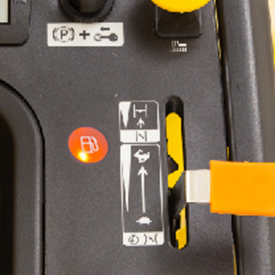 Low fuel warning light illuminated
Low fuel warning light illuminated
The operator station is designed for operator comfort and convenience when operating all controls:
-
Excellent visibility forward and to the trim side of the deck makes operation easy and comfortable for the operator.
-
Controls are color coded for easy identification.
-
Low-fuel warning light is easily visible in daylight.
-
Twin-lever controls adjust, using cut-height pin/socket, for convenience and operator comfort.
-
A shock absorber dampens motion control lever movement to give smooth operation.
Comfortable seat
 Comfortable seat (Z345R shown)
Comfortable seat (Z345R shown)
Comfortable seats make the operator experience more pleasant. Armrests, included on the Z345R, Z355R, and Z375R seat, can be flipped up out of the way, if desired:
-
Z345R, Z355R, and Z375R – 18-in. (46-cm) high seat back with adjustable armrests
Seat suspension
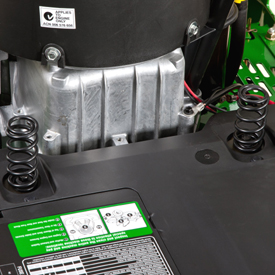 Seat suspension springs
Seat suspension springs
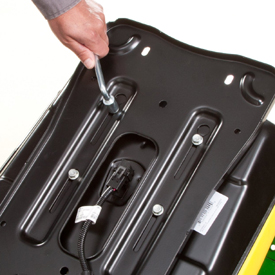 Making seat fore-aft adjustment (Z335E pictured) the Z375R has a seat slide lever
Making seat fore-aft adjustment (Z335E pictured) the Z375R has a seat slide lever
Two steel coil suspension springs under the seat absorb shocks when traveling over rougher areas to provide a smoother ride.
The seat has a 2.5-in. (6.35-cm) fore-aft adjustment. The cut-height pin/socket can be used to loosen the bolts in order to make seat adjustments.
Cup holder and storage compartments
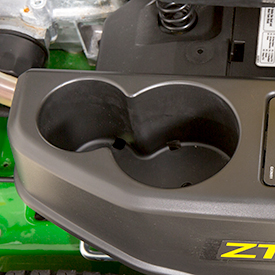 Cup holder
Cup holder

The cup holder is designed to hold two common cup sizes securely.
 Storage compartment with cover located under seat
Storage compartment with cover located under seat
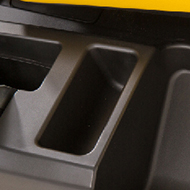 Open storage on left side of vehicle
Open storage on left side of vehicle
 Open storage on left side of vehicle
Open storage on left side of vehicle
Covered storage under the seat and open storage along the left side of the vehicle provide safe and secure places for the operator to keep safety equipment, a cell phone, etc.
Operator foot platform
 Comfortable operator's platform
Comfortable operator's platform

Large foot platform helps the operator remain comfortable and secure:
- Volcano grips give a secure grip.
- Raised footrests at the front of the platform provide a comfortable area for the operator's feet.
Instruments and controls are convenient and easy to use
Motion-control levers
 Operator using motion-control levers
Operator using motion-control levers
 Adjustable motion-control levers
Adjustable motion-control levers
The motion-control levers can be adjusted to two height settings and nine fore-aft settings for a total of 18 different positions:
-
Increased operator comfort
-
Adjustable for more precise control of the machine
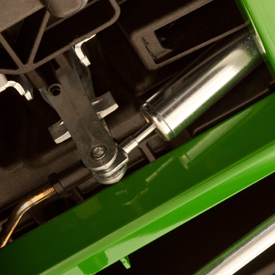 Shock absorber for motion-control levers
Shock absorber for motion-control levers
 Cut-height pin doubles as tracking adjustment tool
Cut-height pin doubles as tracking adjustment tool
A standard shock absorber for the motion-control levers makes maneuvering ZTrak™ Mowers easy and comfortable:
-
Shock absorber modulates the movement of control levers for smoother operation.
-
Operator can smoothly and precisely control the machine.
On-board tracking adjustment from the operator seat is quick and easy. The cut-height pin includes a 13-mm wrench and doubles as a convenient tool for adjusting tracking and the motion-control lever position.
Control panel
 Control panel (Z335E shown)
Control panel (Z335E shown)
 Low fuel warning light illuminated
Low fuel warning light illuminated
The operator control panel is conveniently located and easy to use. The following instruments and controls are included:
- Hourmeter
- Low fuel warning light
- Ignition switch
- Power take-off (PTO) control
- Engine speed/choke control
- A choke position is built into the engine speed control.
Park brake
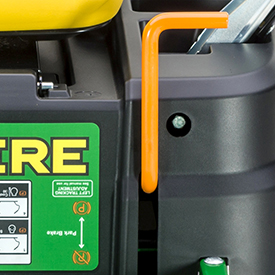 Park brake
Park brake
The park brake is conveniently located:
- Large lever is easy to use.
- Lever is color-coded for easy identification.
- Park brake effectively holds the machine in the parked position.
- Park brake must be engaged (in the upper position) to start the engine.
- Once the engine is started, the park brake must be disengaged before operating the motion-control levers.
Mower deck lift/cut-height adjustment
 Mower deck lift/cut-height adjustment in place
Mower deck lift/cut-height adjustment in place
- Mower deck cutting height adjusts from 1 in. (2.5 cm) to 4 in. (10.2 cm) in 0.25-in. (0.64-cm) increments for excellent cut quality and performance.
- Mower deck adjustment has built-in memory so the operator can easily return to the desired cutting height after raising the deck.
 Foot pedal on Z375R
Foot pedal on Z375R
 Foot pedal on Z345R
Foot pedal on Z345R
The Z345R, Z355R, and Z375R include a foot-lift pedal along with the hand-lift lever to make raising the mower deck easier. The foot-lift pedal also provides a convenient way to temporarily raise the mower deck over an obstruction while mowing.
Electric power take-off (PTO) clutch is easy and convenient to use
 Electric PTO switch
Electric PTO switch
The heavy-duty electric PTO clutch is operated with a convenient dash-mounted switch.
Heavy-duty PTO clutch
 PTO clutch
PTO clutch
The PTO clutch is designed to operate through many on/off cycles.
Reverse implement option (RIO) and interlock switches
 Reverse implement switch
Reverse implement switch
Using RIO
CAUTION: Children or bystanders may be injured by rotating blades. Before traveling forward or rearward:
- Carefully check the area around the machine.
- Disengage the mower before backing up.
NOTE: Operating the mower while backing up is strongly discouraged. RIO should be used only when operating another attachment or when the operator deems it necessary to reposition the machine with the mower engaged.
- Stop forward travel. Allow attachment to run.
- Look down and behind the machine to be sure that there are no bystanders.
- Push and hold in the reverse implement switch while depressing the reverse pedal slightly.
NOTE: If the attachment stops while positioning the machine, return the mower engagement (PTO) switch to off position. Repeat this procedure from the beginning. - Release the reverse implement switch and reposition the machine as the machine begins to move rearward.
- Resume forward travel. The attachment should continue operating.
- Repeat procedure to position the machine again.
Interlock switches
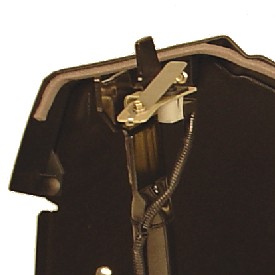 Switch senses if hopper is installed
Switch senses if hopper is installed
A switch senses if the hopper is installed. If the hopper is not installed and the PTO switch is actuated, the PTO will not operate.
A brake interlock switch is provided so the tractor will not start unless the brake is depressed or the parking brake set.
A tractor seat switch will turn off the PTO if the operator leaves the tractor seat; it will also shut-down the engine if the park brake is not set and the operator leaves the seat.
Either the operator needs to be in the seat or the hopper or deflector installed for the engine to run.
Serviceability is designed-in for convenience
 Service interval decal (Z300 Series shown)
Service interval decal (Z300 Series shown)
 Service interval decal (Z500 Series shown)
Service interval decal (Z500 Series shown)
A convenient service interval decal provides basic maintenance information. It provides a quick-reference for keeping recommended service up to date.
Mower deck access
 Footrest easily removed for access to mower (Z335E shown)
Footrest easily removed for access to mower (Z335E shown)
 Footrest removal bolt and hand grip (Z335E shown)
Footrest removal bolt and hand grip (Z335E shown)
The footrest area is hinged and easily raised for service to mower deck:
- It is necessary to remove just one bolt that can be conveniently removed with the lift-height pin.
-
Easy to clean grass off the top of the mower
-
Provides convenient access to the mower drive
 Loosening bolt to remove platform for access to mower deck
Loosening bolt to remove platform for access to mower deck
 Footrest opens for access to mower deck
Footrest opens for access to mower deck
Engine service
 Z335E engine
Z335E engine
 Z335E engine oil and fuel filters shown
Z335E engine oil and fuel filters shown
 Z535M and Z535R engine
Z535M and Z535R engine
 Z540M and Z540R engine
Z540M and Z540R engine
 Easy-to-access oil filter, fill/check oil tube, and oil drain
Easy-to-access oil filter, fill/check oil tube, and oil drain
The engines are easy to service, including changing the oil and the oil filter and servicing the air filter.
 Accel Deep Mower Deck
Accel Deep Mower Deck
 Tie-down locations
Tie-down locations
Accel Deep™ Mower Decks have several features that make them easy to service:
- Flat-top design minimizes places for debris to collect.
- Spring-loaded, flip-up belt guards make removing debris easy.
- Provision is provided for a standard, 3/8-in. (9.5-mm) ratchet wrench to be used for releasing belt tension when removing the drive belt.
Tie-down locations are provided for convenience and safety when trailering the machine.
The 54-in. (138-cm) Accel Deep™ (54A) Mower Deck cuts clean and is versatile
 Z525E ZTrak™ Mower with Accel Deep 54A Mower
Z525E ZTrak™ Mower with Accel Deep 54A Mower
 Accel Deep 54A Mower
Accel Deep 54A Mower
The 54-in. (138-cm) Accel Deep Mower Deck is a stamped-steel, deep, flat-top design that delivers excellent cut quality, productivity, cleanliness, durability, and versatility. Optimal performance and dispersion of clippings is provided, even at faster mowing speeds:
- 4.5-in. (11.4-cm) deep throughout the entire deck shell for optimum mowing, mulching, and bagging performance
- Optional MulchControl™ attachment provides superior mulching performance and versatility.
- Stamped-steel design eliminates sharp edges and corners where material can build up and diminish mowing performance
- Mower deck is suspended from the vehicle for a smooth and level cut
- Adjustable mower wheels, positioned just above ground level, help smooth out the mowing job
Excellent cut quality
 54A Mower top (similar mower from X500 Series Tractor shown)
54A Mower top (similar mower from X500 Series Tractor shown)
 54A Mower underside (similar mower from X500 Series Tractor shown)
54A Mower underside (similar mower from X500 Series Tractor shown)
Deep mower-deck stamping gives excellent cut quality. It allows the cut and suspended material room to exit the deck without getting recut:
- Reducing the amount of recutting enables more power to be used to cut incoming grass, which greatly improves mower capacity.
- Helps maintain excellent cut quality at faster mowing speeds
- Clean flow of material out of discharge area prevents cut material from interfering with cutting the incoming grass, making it possible for the blades to cut incoming material cleanly.
- Even in mulching mode, cut evenness is improved compared to other designs because the additional depth allows for continuous circulation, optimal recutting, and an even distribution of clippings.
Productivity - getting the job done fast
 Right side of Accel Deep 54A Mower Deck
Right side of Accel Deep 54A Mower Deck
Deep mower-deck stamping gives high productivity, which gets the job done fast. It allows the cut and suspended material room to exit the deck quickly, reducing the amount of re-cutting so more power is available to process incoming grass:
- Greatly improves mowers capacity to maintain excellent mowing performance in difficult mowing conditions and at higher speeds
Large discharge opening is both high and wide to handle more material:
- Gives a smooth, even discharge of clippings at all mowing speeds
- Reduces the chance of plugging, especially important when operating in wet, thick, or dense grass and when bagging
- The 54A Power Flow™ blower has an inlet housing with over 50 percent greater area than the 48X Power Flow blower used on previous machines.
Cleanliness - for the mower and the operator
 Accel Deep 54A Mower Deck
Accel Deep 54A Mower Deck
 Accel Deep 54A Mower Deck
Accel Deep 54A Mower Deck
The flat-top shape of the deck stamping is optimal for keeping itself and the operator clean:
- There are few places to catch and hold material on top and underneath the deck.
- Top of deck stays cleaner, reducing time and effort needed for cleaning and service
- Underside of deck is self-cleaning to maintain optimum performance without buildup of material to interfere with the flow of air and clippings
- Less need to clean and remove build-up of material from underside deck
- The depth of the Accel Deep Mower Deck minimizes the amount of material that escapes from the front of the deck
- Limited amount of material to drift onto the operator and mower deck
- Even for material discharged out the chute, less re-cutting results in larger pieces that are less likely to end up on the operator
- Mulching prevents the discharge of material completely and the MulchControl attachment makes mulching a practical solution for most mowing situations.
Cleaning a mower deck, both top and bottom, is one of the most frequent maintenance activities:
- The flat-top design reduces places for material to build up and makes material that does collect easy to remove.
 Mower wash port
Mower wash port
 Mower wash port with hose connector
Mower wash port with hose connector
A wash port is provided to make cleaning the underside of the mower deck easy.
- Hose connector is included with the mower deck.
Superior durability is designed in
 Spindle pocket
Spindle pocket
 Mower wheels are double captured
Mower wheels are double captured
The 54A Mower Deck has strong spindle pockets, to keep the blades aligned, even after years of tough service:
- Ribs in the deck shell add strength where it is needed.
Mower wheels are double captured:
- Provides greater strength and durability for longer, trouble-free life.
- Single-bolt adjustment makes setting wheels to the correct height for the cutting height quick and easy.
Low-tension belt-drive design reduces the side load on engine lower bearings and mower deck bearings for longer life.
The 54A Mower Deck features a 5/8-in. (16-mm) diameter solid-steel rod side bumper that provides extra strength and protection.
Dual-stage E-coat and powder-paint coatings provide extra protection from rust.
Versatility - easy to change between side discharge, mulch, and bagging modes
The 54A Mower is designed for maximum versatility, providing the greatest ease in changing from one mower discharge mode to another:
- With the optional MulchControl attachment installed (along with the special mulching blades), changing from side discharge to mulching or vice versa is done with the simple flip of a lever.
- The Power Flow rear bagger can be used with the MulchControl attachment and blades installed - by simply placing the MulchControl lever in the side discharge position.
MulchControl option
The MulchControl attachment for the 54A Mower Deck makes mulching more practical for many mowing situations because it not only does an excellent job of mulching but it also allows the mower to be easily converted for times when it is more desirable to side discharge or collect the lawn material. Advantages of mulching grass clippings include:
- A beautiful looking lawn
- Grass clippings not blown onto the operator, driveways, or flower beds
- Less fertilizer use
- Elimination of the effort needed to dispose of clippings
How MulchControl works
 MulchControl baffle open
MulchControl baffle open
 MulchControl baffle closed
MulchControl baffle closed
MulchControl is an innovative, simple design that is easy to use and maintain:
- The MulchControl attachment includes baffles to control the flow of material under the deck.
The MulchControl baffle, or divider, between the left and middle spindles is about half way down. The height is designed to balance the mulching and side-discharge modes.
When the MulchControl baffle is open, the divider between the left and middle spindles passes a portion of the material to the discharge opening, along with the material from the middle and right spindle areas.
- When the MulchControl baffle is closed, the material stays within the deck and gets chopped into mulch and deposited in the turf.
 MulchControl baffle closed
MulchControl baffle closed
 MulchControl handle
MulchControl handle
- The MulchControl handle is located on top of the mower deck and used to open and close the discharge baffle.
- The operator is required to get off of the machine in order to engage or disengage mulch mode.
- Changing from mulching to side discharge or vice versa takes only a few seconds.
MulchControl is well-suited to the following mowing situations:
- Usually mulch, but side discharge when grass gets too long
- Usually side-discharge, but would like to be able to close the chute to control clippings
- Always mulch a main lawn, but often side discharge secondary lawns
- Bag clippings, but want to go farther before emptying bags
MulchControl puts the operator in control of the clippings. Now the operator can have all the benefits of mulching with the ability to easily change to side discharge or bagging when needed.
While in the side-discharge mode, MulchControl will still mulch about one third of the material. Therefore, the side-discharge mode is essentially a partial-mulch mode. This can be an advantage when side discharging or bagging, as it helps to reduce the amount of material being discharged. Other times this could work as a disadvantage:
- When cutting strong southern grasses, such as Zoysia and Bermuda
- When cutting in wet, high-growth conditions, such as those found in the Pacific Northwest United States
- When optimum bagging and lawn clean-up is desired
6.5-bu (230-L) Power Flow Rear Bagger (rear bagger not available for ZTrak Z375R)
 Optional rear bagger
Optional rear bagger
 Power Flow blower
Power Flow blower
An optional 6.5-bu (230-L) rear bagger material collection system (MCS) is available. It provides an efficient means of collecting grass clippings and leaves:
- The Power Flow blower and chute are easy to install. The Power Flow blower swings out for easy cleanout and cleanup.
- The hopper design provides modern styling, great bagging performance, cleaner operation, and easy-to-empty bags:
- 6.5-bu (230-L) capacity
- Easy-to-attach Power Flow blower (ordered separately)
- Easy-to-attach chute (ordered separately)
- Air exhaust duct
- Convenient spring-latch
- Airflow fill indicator
- Quik-Tatch mounting
- Sealed hopper top
- Loose-knit bags available
- Hopper kit comes with ballast bracket and (4) weights
Features
Design includes a heavy-duty formed and welded steel frame
 ZTrak™ Z335E shown
ZTrak™ Z335E shown
 ZTrak Z535M shown
ZTrak Z535M shown
ZTrak Mowers are designed around a heavy-duty formed and welded steel frame for strength and reliability.
Large front caster wheels and large rear drive wheels provide several operator benefits:
-
Smoother ride
-
Better slope performance
-
More operator comfort over uneven ground
-
Better traction
The operator platform is roomy and uncluttered for maximum comfort, and the controls are convenient to use:
- Easy to get on and off the mower
- Ample legroom for comfortable operation
- Adjustable motion-control levers for height and position, enabling the operator to stay comfortable while using them
- Color-coded and logically placed controls
Engine is smooth and powerful V-twin design
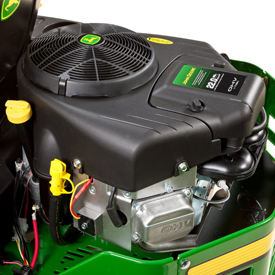 Engine, left rear view
Engine, left rear view
 Engine, right rear view
Engine, right rear view
A V-twin engine with 44.2-cu in. (724-cc) displacement provides plenty of power and torque to handle tough mulching, mowing, and bagging conditions:
- V-twin cylinder design for greater torque, lower vibration, and improved sound quality
- Engine model M44
- Electronic ignition for fast starts
- Cast-iron sleeves for longer engine life
- Overhead valves for excellent power and fuel economy
- Spin-on oil filter with pressure lubrication for keeping the oil cleaner for long engine life and extended time between oil changes; pressure lubrication is also more effective when operating the tractor on an incline
- Easy access to the no-tools oil drain valve for oil changes
- Rear engine guard for protecting the engine and providing additional strength and integrity
 Engine oil check/fill tube and oil-drain tube
Engine oil check/fill tube and oil-drain tube
 Replaceable fuel filter and oil filter
Replaceable fuel filter and oil filter
Replaceable fuel filter and oil filter are easy to access and change to minimize service time and cost.
John Deere recommends the use of fuel stabilizer in gasoline. See Fuel-Protect for gasoline engines (8 oz [237 mL]) for more information
Operator station is designed for comfort and convenience
 Operator station (Z375R shown)
Operator station (Z375R shown)
 Color-coded controls are easy to identify
Color-coded controls are easy to identify
 Low fuel warning light illuminated
Low fuel warning light illuminated
The operator station is designed for operator comfort and convenience when operating all controls:
-
Excellent visibility forward and to the trim side of the deck makes operation easy and comfortable for the operator.
-
Controls are color coded for easy identification.
-
Low-fuel warning light is easily visible in daylight.
-
Twin-lever controls adjust, using cut-height pin/socket, for convenience and operator comfort.
-
A shock absorber dampens motion control lever movement to give smooth operation.
Comfortable seat
 Comfortable seat (Z345R shown)
Comfortable seat (Z345R shown)
Comfortable seats make the operator experience more pleasant. Armrests, included on the Z345R, Z355R, and Z375R seat, can be flipped up out of the way, if desired:
-
Z345R, Z355R, and Z375R – 18-in. (46-cm) high seat back with adjustable armrests
Seat suspension
 Seat suspension springs
Seat suspension springs
 Making seat fore-aft adjustment (Z335E pictured) the Z375R has a seat slide lever
Making seat fore-aft adjustment (Z335E pictured) the Z375R has a seat slide lever
Two steel coil suspension springs under the seat absorb shocks when traveling over rougher areas to provide a smoother ride.
The seat has a 2.5-in. (6.35-cm) fore-aft adjustment. The cut-height pin/socket can be used to loosen the bolts in order to make seat adjustments.
Cup holder and storage compartments
 Cup holder
Cup holder

The cup holder is designed to hold two common cup sizes securely.
 Storage compartment with cover located under seat
Storage compartment with cover located under seat
 Open storage on left side of vehicle
Open storage on left side of vehicle
 Open storage on left side of vehicle
Open storage on left side of vehicle
Covered storage under the seat and open storage along the left side of the vehicle provide safe and secure places for the operator to keep safety equipment, a cell phone, etc.
Operator foot platform
 Comfortable operator's platform
Comfortable operator's platform

Large foot platform helps the operator remain comfortable and secure:
- Volcano grips give a secure grip.
- Raised footrests at the front of the platform provide a comfortable area for the operator's feet.
Instruments and controls are convenient and easy to use
Motion-control levers
 Operator using motion-control levers
Operator using motion-control levers
 Adjustable motion-control levers
Adjustable motion-control levers
The motion-control levers can be adjusted to two height settings and nine fore-aft settings for a total of 18 different positions:
-
Increased operator comfort
-
Adjustable for more precise control of the machine
 Shock absorber for motion-control levers
Shock absorber for motion-control levers
 Cut-height pin doubles as tracking adjustment tool
Cut-height pin doubles as tracking adjustment tool
A standard shock absorber for the motion-control levers makes maneuvering ZTrak™ Mowers easy and comfortable:
-
Shock absorber modulates the movement of control levers for smoother operation.
-
Operator can smoothly and precisely control the machine.
On-board tracking adjustment from the operator seat is quick and easy. The cut-height pin includes a 13-mm wrench and doubles as a convenient tool for adjusting tracking and the motion-control lever position.
Control panel
 Control panel (Z335E shown)
Control panel (Z335E shown)
 Low fuel warning light illuminated
Low fuel warning light illuminated
The operator control panel is conveniently located and easy to use. The following instruments and controls are included:
- Hourmeter
- Low fuel warning light
- Ignition switch
- Power take-off (PTO) control
- Engine speed/choke control
- A choke position is built into the engine speed control.
Park brake
 Park brake
Park brake
The park brake is conveniently located:
- Large lever is easy to use.
- Lever is color-coded for easy identification.
- Park brake effectively holds the machine in the parked position.
- Park brake must be engaged (in the upper position) to start the engine.
- Once the engine is started, the park brake must be disengaged before operating the motion-control levers.
Mower deck lift/cut-height adjustment
 Mower deck lift/cut-height adjustment in place
Mower deck lift/cut-height adjustment in place
- Mower deck cutting height adjusts from 1 in. (2.5 cm) to 4 in. (10.2 cm) in 0.25-in. (0.64-cm) increments for excellent cut quality and performance.
- Mower deck adjustment has built-in memory so the operator can easily return to the desired cutting height after raising the deck.
 Foot pedal on Z375R
Foot pedal on Z375R
 Foot pedal on Z345R
Foot pedal on Z345R
The Z345R, Z355R, and Z375R include a foot-lift pedal along with the hand-lift lever to make raising the mower deck easier. The foot-lift pedal also provides a convenient way to temporarily raise the mower deck over an obstruction while mowing.
Electric power take-off (PTO) clutch is easy and convenient to use
 Electric PTO switch
Electric PTO switch
The heavy-duty electric PTO clutch is operated with a convenient dash-mounted switch.
Heavy-duty PTO clutch
 PTO clutch
PTO clutch
The PTO clutch is designed to operate through many on/off cycles.
Reverse implement option (RIO) and interlock switches
 Reverse implement switch
Reverse implement switch
Using RIO
CAUTION: Children or bystanders may be injured by rotating blades. Before traveling forward or rearward:
- Carefully check the area around the machine.
- Disengage the mower before backing up.
NOTE: Operating the mower while backing up is strongly discouraged. RIO should be used only when operating another attachment or when the operator deems it necessary to reposition the machine with the mower engaged.
- Stop forward travel. Allow attachment to run.
- Look down and behind the machine to be sure that there are no bystanders.
- Push and hold in the reverse implement switch while depressing the reverse pedal slightly.
NOTE: If the attachment stops while positioning the machine, return the mower engagement (PTO) switch to off position. Repeat this procedure from the beginning. - Release the reverse implement switch and reposition the machine as the machine begins to move rearward.
- Resume forward travel. The attachment should continue operating.
- Repeat procedure to position the machine again.
Interlock switches
 Switch senses if hopper is installed
Switch senses if hopper is installed
A switch senses if the hopper is installed. If the hopper is not installed and the PTO switch is actuated, the PTO will not operate.
A brake interlock switch is provided so the tractor will not start unless the brake is depressed or the parking brake set.
A tractor seat switch will turn off the PTO if the operator leaves the tractor seat; it will also shut-down the engine if the park brake is not set and the operator leaves the seat.
Either the operator needs to be in the seat or the hopper or deflector installed for the engine to run.
Serviceability is designed-in for convenience
 Service interval decal (Z300 Series shown)
Service interval decal (Z300 Series shown)
 Service interval decal (Z500 Series shown)
Service interval decal (Z500 Series shown)
A convenient service interval decal provides basic maintenance information. It provides a quick-reference for keeping recommended service up to date.
Mower deck access
 Footrest easily removed for access to mower (Z335E shown)
Footrest easily removed for access to mower (Z335E shown)
 Footrest removal bolt and hand grip (Z335E shown)
Footrest removal bolt and hand grip (Z335E shown)
The footrest area is hinged and easily raised for service to mower deck:
- It is necessary to remove just one bolt that can be conveniently removed with the lift-height pin.
-
Easy to clean grass off the top of the mower
-
Provides convenient access to the mower drive
 Loosening bolt to remove platform for access to mower deck
Loosening bolt to remove platform for access to mower deck
 Footrest opens for access to mower deck
Footrest opens for access to mower deck
Engine service
 Z335E engine
Z335E engine
 Z335E engine oil and fuel filters shown
Z335E engine oil and fuel filters shown
 Z535M and Z535R engine
Z535M and Z535R engine
 Z540M and Z540R engine
Z540M and Z540R engine
 Easy-to-access oil filter, fill/check oil tube, and oil drain
Easy-to-access oil filter, fill/check oil tube, and oil drain
The engines are easy to service, including changing the oil and the oil filter and servicing the air filter.
 Accel Deep Mower Deck
Accel Deep Mower Deck
 Tie-down locations
Tie-down locations
Accel Deep™ Mower Decks have several features that make them easy to service:
- Flat-top design minimizes places for debris to collect.
- Spring-loaded, flip-up belt guards make removing debris easy.
- Provision is provided for a standard, 3/8-in. (9.5-mm) ratchet wrench to be used for releasing belt tension when removing the drive belt.
Tie-down locations are provided for convenience and safety when trailering the machine.
The 48-in. (122-cm) Accel Deep™ (48A) Mower Deck cuts clean and is versatile
 Z535M ZTrak™ Mower with Accel Deep 48A Mower
Z535M ZTrak™ Mower with Accel Deep 48A Mower
 Accel Deep 48A Mower
Accel Deep 48A Mower
The 48-in. (122-cm) Accel Deep Mower Deck is a stamped-steel, deep, flat-top design that delivers excellent cut quality, productivity, cleanliness, durability, and versatility. Optimal performance and dispersion of clippings is provided, even at faster mowing speeds:
- 4.5-in. (11.4-cm) deep throughout the entire deck shell for optimum mowing, mulching, and bagging performance
- Optional MulchControl™ attachment provides superior mulching performance and versatility.
- Stamped-steel design eliminates sharp edges and corners where material can build up and diminish mowing performance
- Mower deck is suspended from the vehicle for a smooth and level cut
- Adjustable mower wheels, positioned just above ground level, help smooth out the mowing job
Excellent cut quality
 48A Mower top (similar mower from X700 Series Tractor shown)
48A Mower top (similar mower from X700 Series Tractor shown)
 48A Mower underside (similar mower from X700 Series Tractor shown)
48A Mower underside (similar mower from X700 Series Tractor shown)
Deep mower-deck stamping gives excellent cut quality. It allows the cut and suspended material room to exit the deck without getting recut:
- Reducing the amount of re-cutting enables more power to be used to cut incoming grass, which greatly improves mower capacity.
- Helps maintain excellent cut quality at faster mowing speeds
- Clean flow of material out of discharge area prevents cut material from interfering with cutting the incoming grass, making it possible for the blades to cut incoming material cleanly.
- Even in mulching mode, cut evenness is improved compared to other designs because the additional depth allows for continuous circulation, optimal re-cutting, and an even distribution of clippings.
Productivity - getting the job done fast
 Right side of Accel Deep 48A Mower Deck
Right side of Accel Deep 48A Mower Deck
Deep mower-deck stamping gives high productivity, which gets the job done fast. It allows the cut and suspended material room to exit the deck quickly, reducing the amount of recutting so more power is available to process incoming grass:
- Greatly improves mowers capacity to maintain excellent mowing performance in difficult mowing conditions and at higher speeds
Large discharge opening is both high and wide to handle more material:
- Gives a smooth, even discharge of clippings at all mowing speeds
- Reduces the chance of plugging, especially important when operating in wet, thick, or dense grass and when bagging
- The 48A Power Flow™ blower has an inlet housing with over 50 percent greater area than the 48X Power Flow blower used on previous machines.
Cleanliness - for the mower and the operator
 Accel Deep 48A Mower Deck
Accel Deep 48A Mower Deck
 Accel Deep 48A Mower Deck
Accel Deep 48A Mower Deck
The flat-top shape of the deck stamping is optimal for keeping itself and the operator clean:
- There are few places to catch and hold material on top and underneath the deck.
- Top of deck stays cleaner, reducing time and effort needed for cleaning and service
- Underside of deck is self-cleaning to maintain optimum performance without buildup of material to interfere with the flow of air and clippings
- Less need to clean and remove buildup of material from underside deck
- The depth of the Accel Deep Mower Deck minimizes the amount of material that escapes from the front of the deck
- Limited amount of material to drift onto the operator and mower deck
- Even for material discharged out the chute, less recutting results in larger pieces that are less likely to end up on the operator
- Mulching prevents the discharge of material completely and the MulchControl attachment makes mulching a practical solution for most mowing situations.
Cleaning a mower deck, both top and bottom, is one of the most frequent maintenance activities:
- The flat-top design reduces places for material to build up and makes material that does collect easy to remove.
 Mower wash port
Mower wash port
 Mower wash port with hose connector
Mower wash port with hose connector
A wash port is provided to make cleaning the underside of the mower deck easy.
- Hose connector is included with the mower deck.
Superior durability is designed in
 Spindle pocket
Spindle pocket
 Mower wheels are double captured
Mower wheels are double captured
The 48A Mower Deck has strong spindle pockets, to keep the blades aligned, even after years of tough service:
- Ribs in the deck shell add strength where it is needed.
- The 48A has a 23 percent heavier overall weight than the Edge™ Xtra 48-in. (122-cm) Mower Deck used on previous machines.
Mower wheels are double-captured:
- Provides greater strength and durability for longer, trouble-free life.
- Single-bolt adjustment makes setting wheels to the correct height for the cutting height quick and easy.
Low-tension belt-drive design reduces the side load on engine lower bearings and mower deck bearings for longer life.
The 48A Mower Deck features a 5/8-in. (16-mm) diameter solid-steel rod side bumper that provides extra strength and protection.
Dual-stage E-coat and powder-paint coatings provide extra protection from rust.
Versatility - easy to change between side discharge, mulch, and bagging modes
The 48A Mower is designed for maximum versatility, providing the greatest ease in changing from one mower discharge mode to another:
- With the optional MulchControl attachment installed (along with the special mulching blades), changing from side-discharge to mulching or vice versa is done with the simple flip of a lever.
- The Power Flow rear bagger can be used with the MulchControl attachment and blades installed - by simply placing the MulchControl lever in the side-discharge position.
MulchControl option
The MulchControl attachment for the 48A Mower Deck makes mulching more practical for many mowing situations because it not only does an excellent job of mulching but it also allows the mower to be easily converted for times when it is more desirable to side discharge or collect the lawn material. Advantages of mulching grass clippings include:
- A beautiful looking lawn
- Grass clippings not blown onto the operator, driveways, or flower beds
- Less fertilizer use
- Elimination of the effort needed to dispose of clippings
How MulchControl works
 MulchControl baffle open (similar mower from X700 Series Tractor shown)
MulchControl baffle open (similar mower from X700 Series Tractor shown)
 MulchControl baffle closed (similar mower from X700 Series Tractor shown)
MulchControl baffle closed (similar mower from X700 Series Tractor shown)
MulchControl is an innovative, simple design that is easy to use and maintain:
- The MulchControl attachment includes baffles to control the flow of material under the deck.
- The MulchControl baffle, or divider, between the left and middle spindles is about half way down. The height is designed to balance the mulching and side-discharge modes.
- When the MulchControl baffle is open, the divider between the left and middle spindles passes a portion of the material to the discharge opening, along with the material from the middle and right spindle areas.
- When the MulchControl baffle is closed, the material stays within the deck and gets chopped into mulch and deposited in the turf.
 MulchControl baffle closed
MulchControl baffle closed
 MulchControl handle
MulchControl handle
- The MulchControl handle is located on top of the mower deck and used to open and close the discharge baffle.
- The operator is required to get off of the machine in order to engage or disengage mulch mode.
- Changing from mulching to side discharge or vice versa takes only a few seconds.
MulchControl is well-suited to the following mowing situations:
- Usually mulch, but side discharge when grass gets too long
- Usually side-discharge, but would like to be able to close the chute to control clippings
- Always mulch a main lawn, but often side discharge secondary lawns
- Bag clippings, but want to go farther before emptying bags
MulchControl puts the operator in control of the clippings. Now the operator can have all the benefits of mulching with the ability to easily change to side discharge or bagging when needed.
While in the side-discharge mode, MulchControl will still mulch about one-third of the material. Therefore, the side-discharge mode is essentially a partial-mulch mode. This can be an advantage when side discharging or bagging, as it helps to reduce the amount of material being discharged. Other times this could work as a disadvantage:
- When cutting strong southern grasses, such as Zoysia and Bermuda
- When cutting in wet, high-growth conditions, such as those found in the Pacific Northwest United States
- When optimum bagging and lawn clean-up is desired
6.5-bu (230-L) Power Flow rear bagger (rear bagger not available for ZTrak Z355E or Z355R)
 Optional rear bagger
Optional rear bagger
 Power Flow blower
Power Flow blower
An optional 6.5-bu (230-L) Power Flow Rear Bagger material collection system (MCS) is available. It provides an efficient means of collecting grass clippings and leaves:
- The Power Flow blower and chute are easy to install. The Power Flow blower swings out for easy cleanout and cleanup.
- The hopper design provides modern styling, great bagging performance, cleaner operation, and easy-to-empty bags:
- 6.5-bu (230-L) capacity
- Easy-to-attach Power Flow blower (ordered separately)
- Easy-to-attach chute (ordered separately)
- Air exhaust duct
- Convenient spring-latch
- Airflow fill indicator
- Quik-Tatch mounting
- Sealed hopper top
- Loose-knit bags available
Features
Design includes a heavy-duty formed and welded steel frame
 ZTrak™ Z335E shown
ZTrak™ Z335E shown
 ZTrak Z535M shown
ZTrak Z535M shown
ZTrak Mowers are designed around a heavy-duty formed and welded steel frame for strength and reliability.
Large front caster wheels and large rear drive wheels provide several operator benefits:
-
Smoother ride
-
Better slope performance
-
More operator comfort over uneven ground
-
Better traction
The operator platform is roomy and uncluttered for maximum comfort, and the controls are convenient to use:
- Easy to get on and off the mower
- Ample legroom for comfortable operation
- Adjustable motion-control levers for height and position, enabling the operator to stay comfortable while using them
- Color-coded and logically placed controls
Engine is smooth and powerful V-twin design
 Engine, left rear view
Engine, left rear view
 Engine, right rear view
Engine, right rear view
A V-twin engine with 44.2-cu in. (724-cc) displacement provides plenty of power and torque to handle tough mulching, mowing, and bagging conditions:
- V-twin cylinder design for greater torque, lower vibration, and improved sound quality
- Engine model M44
- Electronic ignition for fast starts
- Cast-iron sleeves for longer engine life
- Overhead valves for excellent power and fuel economy
- Spin-on oil filter with pressure lubrication for keeping the oil cleaner for long engine life and extended time between oil changes; pressure lubrication is also more effective when operating the tractor on an incline
- Easy access to the no-tools oil drain valve for oil changes
- Rear engine guard for protecting the engine and providing additional strength and integrity
 Engine oil check/fill tube and oil-drain tube
Engine oil check/fill tube and oil-drain tube
 Replaceable fuel filter and oil filter
Replaceable fuel filter and oil filter
Replaceable fuel filter and oil filter are easy to access and change to minimize service time and cost.
John Deere recommends the use of fuel stabilizer in gasoline. See Fuel-Protect for gasoline engines (8 oz [237 mL]) for more information
Operator station is designed for comfort and convenience
 Operator station (Z335E shown)
Operator station (Z335E shown)
 Color-coded controls are easy to identify
Color-coded controls are easy to identify
 Low fuel warning light illuminated
Low fuel warning light illuminated
The operator station is designed for operator comfort and convenience when operating all controls:
-
Excellent visibility forward and to the trim side of the deck makes operation easy and comfortable for the operator.
-
Controls are color coded for easy identification.
-
Low-fuel warning light is easily visible in daylight.
-
Twin-lever controls adjust, using cut-height pin/socket, for convenience and operator comfort.
-
A shock absorber dampens motion control lever movement to give smooth operation.
Comfortable seat
 Comfortable seat (Z335E shown)
Comfortable seat (Z335E shown)
 Comfortable seat (Z355E shown)
Comfortable seat (Z355E shown)
Comfortable seats make the operator experience more pleasant. Armrests, included on the Z355E seat, can be flipped up out of the way, if desired:
-
Z335E – 15-in. (38-cm) high seat back without armrests
-
Z355E – 15-in. (38-cm) high seat back with adjustable armrests
 Comfortable seat (Z345M shown)
Comfortable seat (Z345M shown)
- Z335M and Z345M – 18-in. (46-cm) high seat back with adjustable armrests
Seat suspension
 Seat suspension springs
Seat suspension springs
 Making seat fore-aft adjustment (Z335E)
Making seat fore-aft adjustment (Z335E)
Two steel coil suspension springs under the seat absorb shocks when traveling over rougher areas to provide a smoother ride.
The seat has a 2.5-in. (6.35-cm) fore-aft adjustment. The cut-height pin/socket can be used to loosen the bolts in order to make seat adjustments.
Cup holder and storage compartments
 Cup holder
Cup holder

The cup holder is designed to hold two common cup sizes securely.
 Storage compartment with cover located under seat
Storage compartment with cover located under seat
 Open storage on left side of vehicle
Open storage on left side of vehicle
 Open storage on left side of vehicle
Open storage on left side of vehicle
Covered storage under the seat and open storage along the left side of the vehicle provide safe and secure places for the operator to keep safety equipment, a cell phone, etc.
Operator foot platform
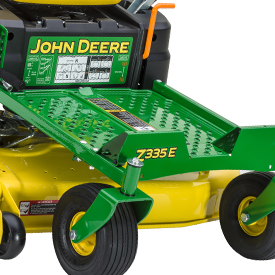 Comfortable operator's platform
Comfortable operator's platform

Large foot platform helps the operator remain comfortable and secure:
- Volcano grips give a secure grip.
- Raised footrests at the front of the platform provide a comfortable area for the operator's feet.
Instruments and controls are convenient and easy to use
Motion-control levers
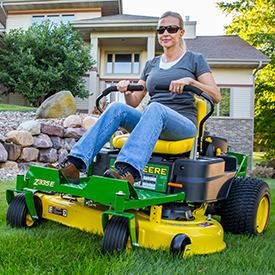 Operator using motion-control levers
Operator using motion-control levers
 Adjustable motion-control levers
Adjustable motion-control levers
The motion-control levers can be adjusted to two height settings and nine fore-aft settings for a total of 18 different positions:
-
Increased operator comfort
-
Adjustable for more precise control of the machine
 Shock absorber for motion-control levers
Shock absorber for motion-control levers
 Cut-height pin doubles as tracking adjustment tool
Cut-height pin doubles as tracking adjustment tool
A standard shock absorber for the motion-control levers makes maneuvering ZTrak™ Mowers easy and comfortable:
-
Shock absorber modulates the movement of control levers for smoother operation.
-
Operator can smoothly and precisely control the machine.
On-board tracking adjustment from the operator seat is quick and easy. The cut-height pin includes a 13-mm wrench and doubles as a convenient tool for adjusting tracking and the motion-control lever position.
Control panel
 Control panel (Z335E shown)
Control panel (Z335E shown)
 Low fuel warning light illuminated
Low fuel warning light illuminated
The operator control panel is conveniently located and easy to use. The following instruments and controls are included:
- Hourmeter
- Low fuel warning light
- Ignition switch
- Power take-off (PTO) control
- Engine speed/choke control
- A choke position is built into the engine speed control.
Park brake
 Park brake
Park brake
The park brake is conveniently located:
- Large lever is easy to use.
- Lever is color-coded for easy identification.
- Park brake effectively holds the machine in the parked position.
- Park brake must be engaged (in the upper position) to start the engine.
- Once the engine is started, the park brake must be disengaged before operating the motion-control levers.
Mower deck lift/cut-height adjustment
 Mower deck lift/cut-height adjustment
Mower deck lift/cut-height adjustment
 Mower deck lift/cut-height adjustment in place
Mower deck lift/cut-height adjustment in place
- Mower deck cutting height adjusts from 1 in. (2.5 cm) to 4 in. (10.2 cm) in 0.25-in. (0.64-cm) increments for excellent cut quality and performance.
- Mower deck adjustment has built-in memory so the operator can easily return to the desired cutting height after raising the deck.
Serviceability is designed-in for convenience
 Service interval decal (Z300 Series shown)
Service interval decal (Z300 Series shown)
 Service interval decal (Z500 Series shown)
Service interval decal (Z500 Series shown)
A convenient service interval decal provides basic maintenance information. It provides a quick-reference for keeping recommended service up to date.
Mower deck access
 Footrest easily removed for access to mower (Z335E shown)
Footrest easily removed for access to mower (Z335E shown)
 Footrest removal bolt and hand grip (Z335E shown)
Footrest removal bolt and hand grip (Z335E shown)
The footrest area is hinged and easily raised for service to mower deck:
- It is necessary to remove just one bolt that can be conveniently removed with the lift-height pin.
-
Easy to clean grass off the top of the mower
-
Provides convenient access to the mower drive
 Loosening bolt to remove platform for access to mower deck
Loosening bolt to remove platform for access to mower deck
 Footrest opens for access to mower deck
Footrest opens for access to mower deck
Engine service
 Z335E engine
Z335E engine
 Z335E engine oil and fuel filters shown
Z335E engine oil and fuel filters shown
 Z535M and Z535R engine
Z535M and Z535R engine
 Z540M and Z540R engine
Z540M and Z540R engine
 Easy-to-access oil filter, fill/check oil tube, and oil drain
Easy-to-access oil filter, fill/check oil tube, and oil drain
The engines are easy to service, including changing the oil and the oil filter and servicing the air filter.
 Accel Deep Mower Deck
Accel Deep Mower Deck
 Tie-down locations
Tie-down locations
Accel Deep™ Mower Decks have several features that make them easy to service:
- Flat-top design minimizes places for debris to collect.
- Spring-loaded, flip-up belt guards make removing debris easy.
- Provision is provided for a standard, 3/8-in. (9.5-mm) ratchet wrench to be used for releasing belt tension when removing the drive belt.
Tie-down locations are provided for convenience and safety when trailering the machine.
The 48-in. (122-cm) Accel Deep™ (48A) Mower Deck cuts clean and is versatile
 Z535M ZTrak™ Mower with Accel Deep 48A Mower
Z535M ZTrak™ Mower with Accel Deep 48A Mower
 Accel Deep 48A Mower
Accel Deep 48A Mower
The 48-in. (122-cm) Accel Deep Mower Deck is a stamped-steel, deep, flat-top design that delivers excellent cut quality, productivity, cleanliness, durability, and versatility. Optimal performance and dispersion of clippings is provided, even at faster mowing speeds:
- 4.5-in. (11.4-cm) deep throughout the entire deck shell for optimum mowing, mulching, and bagging performance
- Optional MulchControl™ attachment provides superior mulching performance and versatility.
- Stamped-steel design eliminates sharp edges and corners where material can build up and diminish mowing performance
- Mower deck is suspended from the vehicle for a smooth and level cut
- Adjustable mower wheels, positioned just above ground level, help smooth out the mowing job
Excellent cut quality
 48A Mower top (similar mower from X700 Series Tractor shown)
48A Mower top (similar mower from X700 Series Tractor shown)
 48A Mower underside (similar mower from X700 Series Tractor shown)
48A Mower underside (similar mower from X700 Series Tractor shown)
Deep mower-deck stamping gives excellent cut quality. It allows the cut and suspended material room to exit the deck without getting recut:
- Reducing the amount of re-cutting enables more power to be used to cut incoming grass, which greatly improves mower capacity.
- Helps maintain excellent cut quality at faster mowing speeds
- Clean flow of material out of discharge area prevents cut material from interfering with cutting the incoming grass, making it possible for the blades to cut incoming material cleanly.
- Even in mulching mode, cut evenness is improved compared to other designs because the additional depth allows for continuous circulation, optimal re-cutting, and an even distribution of clippings.
Productivity - getting the job done fast
 Right side of Accel Deep 48A Mower Deck
Right side of Accel Deep 48A Mower Deck
Deep mower-deck stamping gives high productivity, which gets the job done fast. It allows the cut and suspended material room to exit the deck quickly, reducing the amount of recutting so more power is available to process incoming grass:
- Greatly improves mowers capacity to maintain excellent mowing performance in difficult mowing conditions and at higher speeds
Large discharge opening is both high and wide to handle more material:
- Gives a smooth, even discharge of clippings at all mowing speeds
- Reduces the chance of plugging, especially important when operating in wet, thick, or dense grass and when bagging
- The 48A Power Flow™ blower has an inlet housing with over 50 percent greater area than the 48X Power Flow blower used on previous machines.
Cleanliness - for the mower and the operator
 Accel Deep 48A Mower Deck
Accel Deep 48A Mower Deck
 Accel Deep 48A Mower Deck
Accel Deep 48A Mower Deck
The flat-top shape of the deck stamping is optimal for keeping itself and the operator clean:
- There are few places to catch and hold material on top and underneath the deck.
- Top of deck stays cleaner, reducing time and effort needed for cleaning and service
- Underside of deck is self-cleaning to maintain optimum performance without buildup of material to interfere with the flow of air and clippings
- Less need to clean and remove buildup of material from underside deck
- The depth of the Accel Deep Mower Deck minimizes the amount of material that escapes from the front of the deck
- Limited amount of material to drift onto the operator and mower deck
- Even for material discharged out the chute, less recutting results in larger pieces that are less likely to end up on the operator
- Mulching prevents the discharge of material completely and the MulchControl attachment makes mulching a practical solution for most mowing situations.
Cleaning a mower deck, both top and bottom, is one of the most frequent maintenance activities:
- The flat-top design reduces places for material to build up and makes material that does collect easy to remove.
 Mower wash port
Mower wash port
 Mower wash port with hose connector
Mower wash port with hose connector
A wash port is provided to make cleaning the underside of the mower deck easy.
- Hose connector is included with the mower deck.
Superior durability is designed in
 Spindle pocket
Spindle pocket
 Mower wheels are double captured
Mower wheels are double captured
The 48A Mower Deck has strong spindle pockets, to keep the blades aligned, even after years of tough service:
- Ribs in the deck shell add strength where it is needed.
- The 48A has a 23 percent heavier overall weight than the Edge™ Xtra 48-in. (122-cm) Mower Deck used on previous machines.
Mower wheels are double-captured:
- Provides greater strength and durability for longer, trouble-free life.
- Single-bolt adjustment makes setting wheels to the correct height for the cutting height quick and easy.
Low-tension belt-drive design reduces the side load on engine lower bearings and mower deck bearings for longer life.
The 48A Mower Deck features a 5/8-in. (16-mm) diameter solid-steel rod side bumper that provides extra strength and protection.
Dual-stage E-coat and powder-paint coatings provide extra protection from rust.
Versatility - easy to change between side discharge, mulch, and bagging modes
The 48A Mower is designed for maximum versatility, providing the greatest ease in changing from one mower discharge mode to another:
- With the optional MulchControl attachment installed (along with the special mulching blades), changing from side-discharge to mulching or vice versa is done with the simple flip of a lever.
- The Power Flow rear bagger can be used with the MulchControl attachment and blades installed - by simply placing the MulchControl lever in the side-discharge position.
MulchControl option
The MulchControl attachment for the 48A Mower Deck makes mulching more practical for many mowing situations because it not only does an excellent job of mulching but it also allows the mower to be easily converted for times when it is more desirable to side discharge or collect the lawn material. Advantages of mulching grass clippings include:
- A beautiful looking lawn
- Grass clippings not blown onto the operator, driveways, or flower beds
- Less fertilizer use
- Elimination of the effort needed to dispose of clippings
How MulchControl works
 MulchControl baffle open (similar mower from X700 Series Tractor shown)
MulchControl baffle open (similar mower from X700 Series Tractor shown)
 MulchControl baffle closed (similar mower from X700 Series Tractor shown)
MulchControl baffle closed (similar mower from X700 Series Tractor shown)
MulchControl is an innovative, simple design that is easy to use and maintain:
- The MulchControl attachment includes baffles to control the flow of material under the deck.
- The MulchControl baffle, or divider, between the left and middle spindles is about half way down. The height is designed to balance the mulching and side-discharge modes.
- When the MulchControl baffle is open, the divider between the left and middle spindles passes a portion of the material to the discharge opening, along with the material from the middle and right spindle areas.
- When the MulchControl baffle is closed, the material stays within the deck and gets chopped into mulch and deposited in the turf.
 MulchControl baffle closed
MulchControl baffle closed
 MulchControl handle
MulchControl handle
- The MulchControl handle is located on top of the mower deck and used to open and close the discharge baffle.
- The operator is required to get off of the machine in order to engage or disengage mulch mode.
- Changing from mulching to side discharge or vice versa takes only a few seconds.
MulchControl is well-suited to the following mowing situations:
- Usually mulch, but side discharge when grass gets too long
- Usually side-discharge, but would like to be able to close the chute to control clippings
- Always mulch a main lawn, but often side discharge secondary lawns
- Bag clippings, but want to go farther before emptying bags
MulchControl puts the operator in control of the clippings. Now the operator can have all the benefits of mulching with the ability to easily change to side discharge or bagging when needed.
While in the side-discharge mode, MulchControl will still mulch about one-third of the material. Therefore, the side-discharge mode is essentially a partial-mulch mode. This can be an advantage when side discharging or bagging, as it helps to reduce the amount of material being discharged. Other times this could work as a disadvantage:
- When cutting strong southern grasses, such as Zoysia and Bermuda
- When cutting in wet, high-growth conditions, such as those found in the Pacific Northwest United States
- When optimum bagging and lawn clean-up is desired
6.5-bu (230-L) Power Flow rear bagger (rear bagger not available for ZTrak Z355E or Z355R)
 Optional rear bagger
Optional rear bagger
 Power Flow blower
Power Flow blower
An optional 6.5-bu (230-L) Power Flow Rear Bagger material collection system (MCS) is available. It provides an efficient means of collecting grass clippings and leaves:
- The Power Flow blower and chute are easy to install. The Power Flow blower swings out for easy cleanout and cleanup.
- The hopper design provides modern styling, great bagging performance, cleaner operation, and easy-to-empty bags:
- 6.5-bu (230-L) capacity
- Easy-to-attach Power Flow blower (ordered separately)
- Easy-to-attach chute (ordered separately)
- Air exhaust duct
- Convenient spring-latch
- Airflow fill indicator
- Quik-Tatch mounting
- Sealed hopper top
- Loose-knit bags available
Features
Design includes a heavy-duty formed and welded steel frame
 ZTrak™ Z335E shown
ZTrak™ Z335E shown
 ZTrak Z535M shown
ZTrak Z535M shown
ZTrak Mowers are designed around a heavy-duty formed and welded steel frame for strength and reliability.
Large front caster wheels and large rear drive wheels provide several operator benefits:
-
Smoother ride
-
Better slope performance
-
More operator comfort over uneven ground
-
Better traction
The operator platform is roomy and uncluttered for maximum comfort, and the controls are convenient to use:
- Easy to get on and off the mower
- Ample legroom for comfortable operation
- Adjustable motion-control levers for height and position, enabling the operator to stay comfortable while using them
- Color-coded and logically placed controls
Engine is smooth and powerful V-twin design
 Engine, left rear view
Engine, left rear view
 Engine, right rear view
Engine, right rear view
A V-twin engine with 44.2-cu in. (724-cc) displacement provides plenty of power and torque to handle tough mulching, mowing, and bagging conditions:
- V-twin cylinder design for greater torque, lower vibration, and improved sound quality
- Engine model M44
- Electronic ignition for fast starts
- Cast-iron sleeves for longer engine life
- Overhead valves for excellent power and fuel economy
- Spin-on oil filter with pressure lubrication for keeping the oil cleaner for long engine life and extended time between oil changes; pressure lubrication is also more effective when operating the tractor on an incline
- Easy access to the no-tools oil drain valve for oil changes
- Rear engine guard for protecting the engine and providing additional strength and integrity
 Engine oil check/fill tube and oil-drain tube
Engine oil check/fill tube and oil-drain tube
 Replaceable fuel filter and oil filter
Replaceable fuel filter and oil filter
Replaceable fuel filter and oil filter are easy to access and change to minimize service time and cost.
John Deere recommends the use of fuel stabilizer in gasoline. See Fuel-Protect for gasoline engines (8 oz [237 mL]) for more information
Operator station is designed for comfort and convenience
 Operator station (Z375R shown)
Operator station (Z375R shown)
 Color-coded controls are easy to identify
Color-coded controls are easy to identify
 Low fuel warning light illuminated
Low fuel warning light illuminated
The operator station is designed for operator comfort and convenience when operating all controls:
-
Excellent visibility forward and to the trim side of the deck makes operation easy and comfortable for the operator.
-
Controls are color coded for easy identification.
-
Low-fuel warning light is easily visible in daylight.
-
Twin-lever controls adjust, using cut-height pin/socket, for convenience and operator comfort.
-
A shock absorber dampens motion control lever movement to give smooth operation.
Comfortable seat
 Comfortable seat (Z345R shown)
Comfortable seat (Z345R shown)
Comfortable seats make the operator experience more pleasant. Armrests, included on the Z345R, Z355R, and Z375R seat, can be flipped up out of the way, if desired:
-
Z345R, Z355R, and Z375R – 18-in. (46-cm) high seat back with adjustable armrests
Seat suspension
 Seat suspension springs
Seat suspension springs
 Making seat fore-aft adjustment (Z335E pictured) the Z375R has a seat slide lever
Making seat fore-aft adjustment (Z335E pictured) the Z375R has a seat slide lever
Two steel coil suspension springs under the seat absorb shocks when traveling over rougher areas to provide a smoother ride.
The seat has a 2.5-in. (6.35-cm) fore-aft adjustment. The cut-height pin/socket can be used to loosen the bolts in order to make seat adjustments.
Cup holder and storage compartments
 Cup holder
Cup holder

The cup holder is designed to hold two common cup sizes securely.
 Storage compartment with cover located under seat
Storage compartment with cover located under seat
 Open storage on left side of vehicle
Open storage on left side of vehicle
 Open storage on left side of vehicle
Open storage on left side of vehicle
Covered storage under the seat and open storage along the left side of the vehicle provide safe and secure places for the operator to keep safety equipment, a cell phone, etc.
Operator foot platform
 Comfortable operator's platform
Comfortable operator's platform

Large foot platform helps the operator remain comfortable and secure:
- Volcano grips give a secure grip.
- Raised footrests at the front of the platform provide a comfortable area for the operator's feet.
Instruments and controls are convenient and easy to use
Motion-control levers
 Operator using motion-control levers
Operator using motion-control levers
 Adjustable motion-control levers
Adjustable motion-control levers
The motion-control levers can be adjusted to two height settings and nine fore-aft settings for a total of 18 different positions:
-
Increased operator comfort
-
Adjustable for more precise control of the machine
 Shock absorber for motion-control levers
Shock absorber for motion-control levers
 Cut-height pin doubles as tracking adjustment tool
Cut-height pin doubles as tracking adjustment tool
A standard shock absorber for the motion-control levers makes maneuvering ZTrak™ Mowers easy and comfortable:
-
Shock absorber modulates the movement of control levers for smoother operation.
-
Operator can smoothly and precisely control the machine.
On-board tracking adjustment from the operator seat is quick and easy. The cut-height pin includes a 13-mm wrench and doubles as a convenient tool for adjusting tracking and the motion-control lever position.
Control panel
 Control panel (Z335E shown)
Control panel (Z335E shown)
 Low fuel warning light illuminated
Low fuel warning light illuminated
The operator control panel is conveniently located and easy to use. The following instruments and controls are included:
- Hourmeter
- Low fuel warning light
- Ignition switch
- Power take-off (PTO) control
- Engine speed/choke control
- A choke position is built into the engine speed control.
Park brake
 Park brake
Park brake
The park brake is conveniently located:
- Large lever is easy to use.
- Lever is color-coded for easy identification.
- Park brake effectively holds the machine in the parked position.
- Park brake must be engaged (in the upper position) to start the engine.
- Once the engine is started, the park brake must be disengaged before operating the motion-control levers.
Mower deck lift/cut-height adjustment
 Mower deck lift/cut-height adjustment in place
Mower deck lift/cut-height adjustment in place
- Mower deck cutting height adjusts from 1 in. (2.5 cm) to 4 in. (10.2 cm) in 0.25-in. (0.64-cm) increments for excellent cut quality and performance.
- Mower deck adjustment has built-in memory so the operator can easily return to the desired cutting height after raising the deck.
 Foot pedal on Z375R
Foot pedal on Z375R
 Foot pedal on Z345R
Foot pedal on Z345R
The Z345R, Z355R, and Z375R include a foot-lift pedal along with the hand-lift lever to make raising the mower deck easier. The foot-lift pedal also provides a convenient way to temporarily raise the mower deck over an obstruction while mowing.
Electric power take-off (PTO) clutch is easy and convenient to use
 Electric PTO switch
Electric PTO switch
The heavy-duty electric PTO clutch is operated with a convenient dash-mounted switch.
Heavy-duty PTO clutch
 PTO clutch
PTO clutch
The PTO clutch is designed to operate through many on/off cycles.
Reverse implement option (RIO) and interlock switches
 Reverse implement switch
Reverse implement switch
Using RIO
CAUTION: Children or bystanders may be injured by rotating blades. Before traveling forward or rearward:
- Carefully check the area around the machine.
- Disengage the mower before backing up.
NOTE: Operating the mower while backing up is strongly discouraged. RIO should be used only when operating another attachment or when the operator deems it necessary to reposition the machine with the mower engaged.
- Stop forward travel. Allow attachment to run.
- Look down and behind the machine to be sure that there are no bystanders.
- Push and hold in the reverse implement switch while depressing the reverse pedal slightly.
NOTE: If the attachment stops while positioning the machine, return the mower engagement (PTO) switch to off position. Repeat this procedure from the beginning. - Release the reverse implement switch and reposition the machine as the machine begins to move rearward.
- Resume forward travel. The attachment should continue operating.
- Repeat procedure to position the machine again.
Interlock switches
 Switch senses if hopper is installed
Switch senses if hopper is installed
A switch senses if the hopper is installed. If the hopper is not installed and the PTO switch is actuated, the PTO will not operate.
A brake interlock switch is provided so the tractor will not start unless the brake is depressed or the parking brake set.
A tractor seat switch will turn off the PTO if the operator leaves the tractor seat; it will also shut-down the engine if the park brake is not set and the operator leaves the seat.
Either the operator needs to be in the seat or the hopper or deflector installed for the engine to run.
Serviceability is designed-in for convenience
 Service interval decal (Z300 Series shown)
Service interval decal (Z300 Series shown)
 Service interval decal (Z500 Series shown)
Service interval decal (Z500 Series shown)
A convenient service interval decal provides basic maintenance information. It provides a quick-reference for keeping recommended service up to date.
Mower deck access
 Footrest easily removed for access to mower (Z335E shown)
Footrest easily removed for access to mower (Z335E shown)
 Footrest removal bolt and hand grip (Z335E shown)
Footrest removal bolt and hand grip (Z335E shown)
The footrest area is hinged and easily raised for service to mower deck:
- It is necessary to remove just one bolt that can be conveniently removed with the lift-height pin.
-
Easy to clean grass off the top of the mower
-
Provides convenient access to the mower drive
 Loosening bolt to remove platform for access to mower deck
Loosening bolt to remove platform for access to mower deck
 Footrest opens for access to mower deck
Footrest opens for access to mower deck
Engine service
 Z335E engine
Z335E engine
 Z335E engine oil and fuel filters shown
Z335E engine oil and fuel filters shown
 Z535M and Z535R engine
Z535M and Z535R engine
 Z540M and Z540R engine
Z540M and Z540R engine
 Easy-to-access oil filter, fill/check oil tube, and oil drain
Easy-to-access oil filter, fill/check oil tube, and oil drain
The engines are easy to service, including changing the oil and the oil filter and servicing the air filter.
 Accel Deep Mower Deck
Accel Deep Mower Deck
 Tie-down locations
Tie-down locations
Accel Deep™ Mower Decks have several features that make them easy to service:
- Flat-top design minimizes places for debris to collect.
- Spring-loaded, flip-up belt guards make removing debris easy.
- Provision is provided for a standard, 3/8-in. (9.5-mm) ratchet wrench to be used for releasing belt tension when removing the drive belt.
Tie-down locations are provided for convenience and safety when trailering the machine.
The 42-in. (107-cm) Accel Deep™ (42A) Mower Deck cuts clean and is versatile
 Z335E ZTrak™ with Accel Deep 42A Mower
Z335E ZTrak™ with Accel Deep 42A Mower
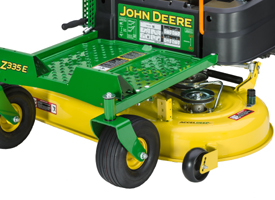 Accel Deep 42A Mower
Accel Deep 42A Mower
The 42-in. (107-cm) Accel Deep Mower Deck is a stamped-steel, deep, flat-top design that delivers excellent cut quality, productivity, cleanliness, durability, and versatility. Optimal performance and dispersion of clippings is provided, even at faster mowing speeds:
- 4.5-in. (11.4-cm) deep throughout the entire deck shell for optimum mowing, mulching, and bagging performance
- Optional MulchControl™ attachment for superior mulching performance and versatility
- Stamped-steel design eliminates sharp edges and corners where material can build up and diminish mowing performance
- Mower deck suspended from the vehicle for a smooth and level cut
- Adjustable mower wheels, positioned just above ground level, for reduced scalping
Excellent cut quality
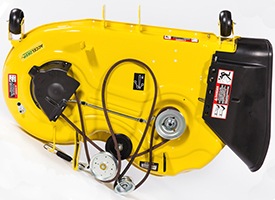 42A Mower top (similar mower from X300 Series Tractor shown)
42A Mower top (similar mower from X300 Series Tractor shown)
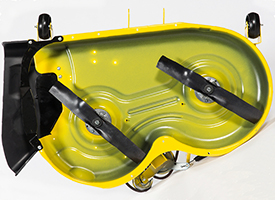 42A Mower underside (similar mower from X300 Series Tractor shown)
42A Mower underside (similar mower from X300 Series Tractor shown)
Deep mower-deck stamping gives excellent cut quality. It allows the cut and suspended material room to exit the deck without getting recut:
- Reducing the amount of recutting enables more power to be used to cut incoming grass, which greatly improves mower capacity.
- Helps maintain excellent cut quality at faster mowing speeds
- Clean flow of material out of discharge area prevents cut material from interfering with cutting the incoming grass, making it possible for the blades to cut incoming material cleanly.
- Even in mulching mode, cut evenness is improved compared to other designs because the additional depth allows for continuous circulation, optimal recutting, and an even distribution of clippings.
Productivity - gets the job done fast
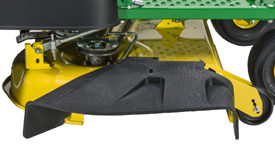 Side-discharge chute on Accel Deep 42A Mower Deck
Side-discharge chute on Accel Deep 42A Mower Deck
Deep mower-deck stamping gives high productivity, which gets the job done fast. It allows the cut and suspended material room to exit the deck quickly, reducing the amount of re-cutting so more power is available to process incoming grass:
- Greatly improves the mower's capacity to maintain excellent mowing performance in difficult mowing conditions and at higher speeds
Large discharge opening is both high and wide to handle more material:
- Gives a smooth, even discharge of clippings at all mowing speeds
- Reduces the chance of plugging, especially important when operating in wet, thick, or dense grass and when bagging
- Cut-and-throw chute has a large, optimized inlet which aids in collecting material by using airflow from the large deck opening
Cleanliness - for the mower and the operator
 Accel Deep 42A Mower Deck
Accel Deep 42A Mower Deck
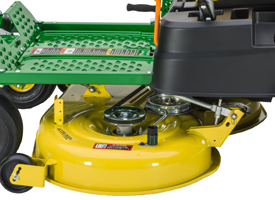 Accel Deep 42A Mower Deck
Accel Deep 42A Mower Deck
The flat-top shape of the deck stamping is optimal for keeping itself and the operator clean:
- There are few places to catch and hold material on the top and underneath the deck.
- Top of deck stays cleaner, reducing time and effort needed for cleaning and service
- Underside of deck is self-cleaning to maintain optimum performance without build-up of material to interfere with the flow of air and clippings
- Less need to clean and remove build-up of material from underside deck
- The depth of the Accel Deep Mower Deck minimizes the amount of material that escapes from the front of the deck
- Limited amount of material to drift onto the operator and mower deck
- Even flow of material discharged out the chute, less re-cutting results in larger pieces that are less likely to end up on the operator
- Mulching prevents the discharge of material completely
- Versatility of MulchControl attachment makes mulching a practical solution for most mowing situations
Cleaning a mower deck, both top and bottom, is one of the most frequent maintenance activities:
- The flat-top design reduces places for material to build up and makes material that does collect easy to remove.
 Mower wash port
Mower wash port
 Mower wash port with hose connector
Mower wash port with hose connector
A wash port is provided to make cleaning the underside of the mower deck easy.
- Hose connector is included with the mower deck.
Superior durability is designed in
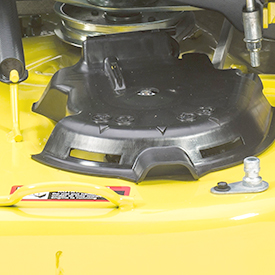 Spindle pockets on the 42A Mower
Spindle pockets on the 42A Mower
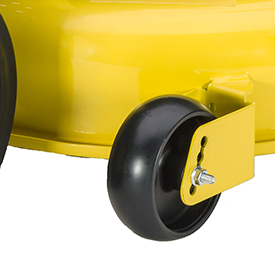 Mower wheels are double-captured
Mower wheels are double-captured
The 42A Mower Deck has strong spindle pockets, to keep the blades aligned, even after years of tough service:
- Ribs in the deck shell add strength where it is needed.
- The 42A has a 16 percent heavier overall weight than the Edge™ Xtra 42-in. (107-cm) Mower Deck that it replaces.
Mower wheels are double-captured:
- Provides greater strength and durability for longer, trouble-free life.
- Single-bolt adjustment makes setting wheels to the correct height for the cutting height quick and easy.
Low-tension belt-drive design reduces the side load on the engines lower bearing and mower deck bearings for longer life.
Rolled outer edge of the deck provides extra strength and protection.
Dual-stage E-coat and powder-paint coatings provide extra protection from rust.
Versatility - easy to change between side discharge, mulch, and bagging modes
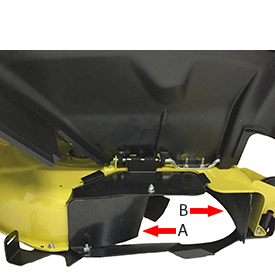 Rear MulchControl baffle (A) that must be removed for bagging
Rear MulchControl baffle (A) that must be removed for bagging
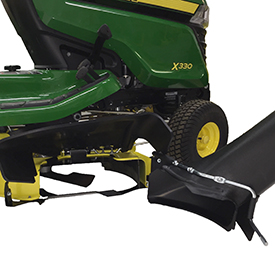 Rear MulchControl baffle removed to allow for chute installation (Mower shown on X330 Tractor)
Rear MulchControl baffle removed to allow for chute installation (Mower shown on X330 Tractor)
The 42A Mower is designed for maximum versatility, providing the greatest ease in changing from one mower discharge mode to another:
- The mower's cut-and-throw design allows bagging with just the addition of the bagger chute, once the special bagging blades have been installed.
- The 42A cut-and-throw chute is easy to install and securely held in place at the front and rear to provide a tight seal between the mower deck and the chute.
- The rear latch is adjustable to allow for the optimum setting for easy use and a tight seal.
- The bagging blades can be used for side discharging also.
- The 42A cut-and-throw chute is easy to install and securely held in place at the front and rear to provide a tight seal between the mower deck and the chute.
- With the optional MulchControl attachment installed (along with the special mulching blades), changing from side-discharge to mulching or vice versa is done with the simple flip of a lever.
- The rear bagger can be used with the MulchControl blades installed.
- The front baffle, either the one included with the rear bagger chute or the one included with MulchControl (B), can remain in place for side discharging.
- For ultimate side-discharge performance this baffle can be removed.
- The optional MulchControl attachment includes a rear MulchControl baffle (A), held in place by two carriage bolts, at the rear edge of the discharge opening. This baffle:
- Must be removed for installation of the rear bagger chute, a 13-mm (0.51-in.) wrench is required (the bagger chute cannot be installed without removing this baffle)
- Can remain removed for side discharging material
- Must be re-installed for mulching
MulchControl option
The MulchControl attachment for the 42A Mower Deck makes mulching more practical for many mowing situations because it not only does an excellent job of mulching but it also allows the mower to be easily converted for times when it is more desirable to side discharge or collect the lawn material. Advantages of mulching grass clippings include:
- A beautiful looking lawn
- Grass clippings not blown onto the operator, driveways, or flower beds
- Less fertilizer use
- Elimination of the effort needed to dispose of clippings
How MulchControl works
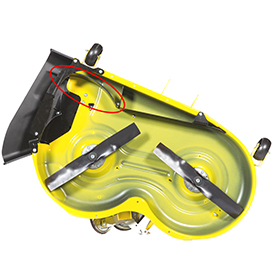 MulchControl baffle open
MulchControl baffle open
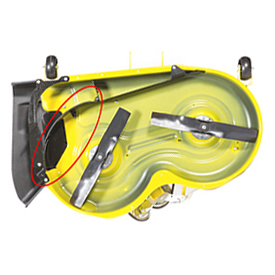 MulchControl baffle closed
MulchControl baffle closed
MulchControl is an innovative, simple design that is easy to use and maintain:
- The MulchControl attachment includes baffles to control the flow of material under the deck.
- When the MulchControl baffle is open, most of the material passes through the discharge opening.
- When the MulchControl baffle is closed, the material stays within the deck and gets chopped into mulch and deposited in the turf.
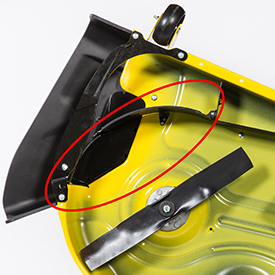 MulchControl baffle closed
MulchControl baffle closed
 MulchControl handle
MulchControl handle
- The MulchControl handle is located on top of the mower deck and used to open and close the discharge baffle.
- The operator is required to get off of the machine in order to engage or disengage mulch mode.
- Changing from mulching to side discharge or vice versa takes only a few seconds.
MulchControl is well-suited to the following mowing situations:
- Usually mulch, but side discharge when grass gets too long
- Usually side-discharge, but would like to be able to close the chute to control clippings
- Always mulch a main lawn, but often side discharge secondary lawns
- Bag clippings, but want to go farther before emptying bags
While in the side-discharge mode, MulchControl will still mulch about one third of the material. Therefore, the side-discharge mode is essentially a partial-mulch mode. This can be an advantage when side discharging or bagging, as it helps to reduce the amount of material being discharged. Other times this could work as a disadvantage:
- When cutting strong southern grasses, such as Zoysia and Bermuda
- When cutting in wet, high-growth conditions, such as those found in the Pacific Northwest United States
- When optimum bagging and lawn clean-up is desired
6.5-bu (230-L) rear bagger
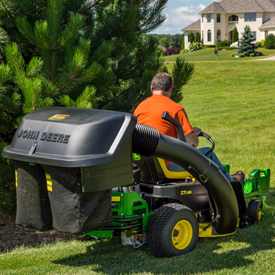 Z335E equipped with optional rear bagger
Z335E equipped with optional rear bagger
An optional 6.5-bu (230-L) cut-and-throw rear bagger material collection system (MCS) is available for use with the 42-in. (107-cm) Accel Deep Mower. It provides an efficient means of collecting grass clippings and leaves.
The hopper design provides modern styling, great bagging performance, cleaner operation, and easy-to-empty bags:
- 6.5-bu (230-L) capacity
- Easy-to-attach lower chute
- Air exhaust duct
- Convenient spring-latch
- Airflow fill indicator
- Quik-Tatch mounting
- Sealed hopper top
- Loose-knit bags available
Mower blades
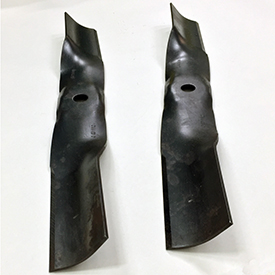 Mower blades shipped with the rear bagger
Mower blades shipped with the rear bagger
High-lift bagging blades are included with the chute. They provide optimum performance when bagging in difficult conditions, such as when the grass is moist, dense, or long:
- High-lift bagging blades also work well when side discharging material.
Mulching blades are included with the MulchControl attachment. They can be used for mulching, side discharging, and bagging in most conditions.
Mower blade use chart
| Mode(s) of operation | Mower blade |
| Side discharging mode only | M170639 side-discharge blade (shipped with mower) |
| Bagging mode only | GX25668 bagging blade (shipped with BG20754 rear bagger chute) |
| Mulching mode only | M170642 mulching blade (shipped with BM24794 MulchControl) |
| Side discharge and mulching | M170642 mulching blade (shipped with BM24794 MulchControl) |
| Side discharge and bagging | GX25668 bagging blade (shipped with BG20754 rear bagger chute) |
| Side discharge, mulching, and bagging | M170642 mulching blade (shipped with BM24794 MulchControl) |
Features
Design includes a heavy-duty formed and welded steel frame
 ZTrak™ Z335E shown
ZTrak™ Z335E shown
 ZTrak Z535M shown
ZTrak Z535M shown
ZTrak Mowers are designed around a heavy-duty formed and welded steel frame for strength and reliability.
Large front caster wheels and large rear drive wheels provide several operator benefits:
-
Smoother ride
-
Better slope performance
-
More operator comfort over uneven ground
-
Better traction
The operator platform is roomy and uncluttered for maximum comfort, and the controls are convenient to use:
- Easy to get on and off the mower
- Ample legroom for comfortable operation
- Adjustable motion-control levers for height and position, enabling the operator to stay comfortable while using them
- Color-coded and logically placed controls
Engine is smooth and powerful V-twin design
 Engine, left rear view
Engine, left rear view
 Engine, right rear view
Engine, right rear view
A V-twin engine with 44.2-cu in. (724-cc) displacement provides plenty of power and torque to handle tough mulching, mowing, and bagging conditions:
- V-twin cylinder design for greater torque, lower vibration, and improved sound quality
- Engine model M44
- Electronic ignition for fast starts
- Cast-iron sleeves for longer engine life
- Overhead valves for excellent power and fuel economy
- Spin-on oil filter with pressure lubrication for keeping the oil cleaner for long engine life and extended time between oil changes; pressure lubrication is also more effective when operating the tractor on an incline
- Easy access to the no-tools oil drain valve for oil changes
- Rear engine guard for protecting the engine and providing additional strength and integrity
 Engine oil check/fill tube and oil-drain tube
Engine oil check/fill tube and oil-drain tube
 Replaceable fuel filter and oil filter
Replaceable fuel filter and oil filter
Replaceable fuel filter and oil filter are easy to access and change to minimize service time and cost.
John Deere recommends the use of fuel stabilizer in gasoline. See Fuel-Protect for gasoline engines (8 oz [237 mL]) for more information
Operator station is designed for comfort and convenience
 Operator station (Z335E shown)
Operator station (Z335E shown)
 Color-coded controls are easy to identify
Color-coded controls are easy to identify
 Low fuel warning light illuminated
Low fuel warning light illuminated
The operator station is designed for operator comfort and convenience when operating all controls:
-
Excellent visibility forward and to the trim side of the deck makes operation easy and comfortable for the operator.
-
Controls are color coded for easy identification.
-
Low-fuel warning light is easily visible in daylight.
-
Twin-lever controls adjust, using cut-height pin/socket, for convenience and operator comfort.
-
A shock absorber dampens motion control lever movement to give smooth operation.
Comfortable seat
 Comfortable seat (Z335E shown)
Comfortable seat (Z335E shown)
 Comfortable seat (Z355E shown)
Comfortable seat (Z355E shown)
Comfortable seats make the operator experience more pleasant. Armrests, included on the Z355E seat, can be flipped up out of the way, if desired:
-
Z335E – 15-in. (38-cm) high seat back without armrests
-
Z355E – 15-in. (38-cm) high seat back with adjustable armrests
 Comfortable seat (Z345M shown)
Comfortable seat (Z345M shown)
- Z335M and Z345M – 18-in. (46-cm) high seat back with adjustable armrests
Seat suspension
 Seat suspension springs
Seat suspension springs
 Making seat fore-aft adjustment (Z335E)
Making seat fore-aft adjustment (Z335E)
Two steel coil suspension springs under the seat absorb shocks when traveling over rougher areas to provide a smoother ride.
The seat has a 2.5-in. (6.35-cm) fore-aft adjustment. The cut-height pin/socket can be used to loosen the bolts in order to make seat adjustments.
Cup holder and storage compartments
 Cup holder
Cup holder

The cup holder is designed to hold two common cup sizes securely.
 Storage compartment with cover located under seat
Storage compartment with cover located under seat
 Open storage on left side of vehicle
Open storage on left side of vehicle
 Open storage on left side of vehicle
Open storage on left side of vehicle
Covered storage under the seat and open storage along the left side of the vehicle provide safe and secure places for the operator to keep safety equipment, a cell phone, etc.
Operator foot platform
 Comfortable operator's platform
Comfortable operator's platform

Large foot platform helps the operator remain comfortable and secure:
- Volcano grips give a secure grip.
- Raised footrests at the front of the platform provide a comfortable area for the operator's feet.
Instruments and controls are convenient and easy to use
Motion-control levers
 Operator using motion-control levers
Operator using motion-control levers
 Adjustable motion-control levers
Adjustable motion-control levers
The motion-control levers can be adjusted to two height settings and nine fore-aft settings for a total of 18 different positions:
-
Increased operator comfort
-
Adjustable for more precise control of the machine
 Shock absorber for motion-control levers
Shock absorber for motion-control levers
 Cut-height pin doubles as tracking adjustment tool
Cut-height pin doubles as tracking adjustment tool
A standard shock absorber for the motion-control levers makes maneuvering ZTrak™ Mowers easy and comfortable:
-
Shock absorber modulates the movement of control levers for smoother operation.
-
Operator can smoothly and precisely control the machine.
On-board tracking adjustment from the operator seat is quick and easy. The cut-height pin includes a 13-mm wrench and doubles as a convenient tool for adjusting tracking and the motion-control lever position.
Control panel
 Control panel (Z335E shown)
Control panel (Z335E shown)
 Low fuel warning light illuminated
Low fuel warning light illuminated
The operator control panel is conveniently located and easy to use. The following instruments and controls are included:
- Hourmeter
- Low fuel warning light
- Ignition switch
- Power take-off (PTO) control
- Engine speed/choke control
- A choke position is built into the engine speed control.
Park brake
 Park brake
Park brake
The park brake is conveniently located:
- Large lever is easy to use.
- Lever is color-coded for easy identification.
- Park brake effectively holds the machine in the parked position.
- Park brake must be engaged (in the upper position) to start the engine.
- Once the engine is started, the park brake must be disengaged before operating the motion-control levers.
Mower deck lift/cut-height adjustment
 Mower deck lift/cut-height adjustment
Mower deck lift/cut-height adjustment
 Mower deck lift/cut-height adjustment in place
Mower deck lift/cut-height adjustment in place
- Mower deck cutting height adjusts from 1 in. (2.5 cm) to 4 in. (10.2 cm) in 0.25-in. (0.64-cm) increments for excellent cut quality and performance.
- Mower deck adjustment has built-in memory so the operator can easily return to the desired cutting height after raising the deck.
Serviceability is designed-in for convenience
 Service interval decal (Z300 Series shown)
Service interval decal (Z300 Series shown)
 Service interval decal (Z500 Series shown)
Service interval decal (Z500 Series shown)
A convenient service interval decal provides basic maintenance information. It provides a quick-reference for keeping recommended service up to date.
Mower deck access
 Footrest easily removed for access to mower (Z335E shown)
Footrest easily removed for access to mower (Z335E shown)
 Footrest removal bolt and hand grip (Z335E shown)
Footrest removal bolt and hand grip (Z335E shown)
The footrest area is hinged and easily raised for service to mower deck:
- It is necessary to remove just one bolt that can be conveniently removed with the lift-height pin.
-
Easy to clean grass off the top of the mower
-
Provides convenient access to the mower drive
 Loosening bolt to remove platform for access to mower deck
Loosening bolt to remove platform for access to mower deck
 Footrest opens for access to mower deck
Footrest opens for access to mower deck
Engine service
 Z335E engine
Z335E engine
 Z335E engine oil and fuel filters shown
Z335E engine oil and fuel filters shown
 Z535M and Z535R engine
Z535M and Z535R engine
 Z540M and Z540R engine
Z540M and Z540R engine
 Easy-to-access oil filter, fill/check oil tube, and oil drain
Easy-to-access oil filter, fill/check oil tube, and oil drain
The engines are easy to service, including changing the oil and the oil filter and servicing the air filter.
 Accel Deep Mower Deck
Accel Deep Mower Deck
 Tie-down locations
Tie-down locations
Accel Deep™ Mower Decks have several features that make them easy to service:
- Flat-top design minimizes places for debris to collect.
- Spring-loaded, flip-up belt guards make removing debris easy.
- Provision is provided for a standard, 3/8-in. (9.5-mm) ratchet wrench to be used for releasing belt tension when removing the drive belt.
Tie-down locations are provided for convenience and safety when trailering the machine.
The 42-in. (107-cm) Accel Deep™ (42A) Mower Deck cuts clean and is versatile
 Z335E ZTrak™ with Accel Deep 42A Mower
Z335E ZTrak™ with Accel Deep 42A Mower
 Accel Deep 42A Mower
Accel Deep 42A Mower
The 42-in. (107-cm) Accel Deep Mower Deck is a stamped-steel, deep, flat-top design that delivers excellent cut quality, productivity, cleanliness, durability, and versatility. Optimal performance and dispersion of clippings is provided, even at faster mowing speeds:
- 4.5-in. (11.4-cm) deep throughout the entire deck shell for optimum mowing, mulching, and bagging performance
- Optional MulchControl™ attachment for superior mulching performance and versatility
- Stamped-steel design eliminates sharp edges and corners where material can build up and diminish mowing performance
- Mower deck suspended from the vehicle for a smooth and level cut
- Adjustable mower wheels, positioned just above ground level, for reduced scalping
Excellent cut quality
 42A Mower top (similar mower from X300 Series Tractor shown)
42A Mower top (similar mower from X300 Series Tractor shown)
 42A Mower underside (similar mower from X300 Series Tractor shown)
42A Mower underside (similar mower from X300 Series Tractor shown)
Deep mower-deck stamping gives excellent cut quality. It allows the cut and suspended material room to exit the deck without getting recut:
- Reducing the amount of recutting enables more power to be used to cut incoming grass, which greatly improves mower capacity.
- Helps maintain excellent cut quality at faster mowing speeds
- Clean flow of material out of discharge area prevents cut material from interfering with cutting the incoming grass, making it possible for the blades to cut incoming material cleanly.
- Even in mulching mode, cut evenness is improved compared to other designs because the additional depth allows for continuous circulation, optimal recutting, and an even distribution of clippings.
Productivity - gets the job done fast
 Side-discharge chute on Accel Deep 42A Mower Deck
Side-discharge chute on Accel Deep 42A Mower Deck
Deep mower-deck stamping gives high productivity, which gets the job done fast. It allows the cut and suspended material room to exit the deck quickly, reducing the amount of re-cutting so more power is available to process incoming grass:
- Greatly improves the mower's capacity to maintain excellent mowing performance in difficult mowing conditions and at higher speeds
Large discharge opening is both high and wide to handle more material:
- Gives a smooth, even discharge of clippings at all mowing speeds
- Reduces the chance of plugging, especially important when operating in wet, thick, or dense grass and when bagging
- Cut-and-throw chute has a large, optimized inlet which aids in collecting material by using airflow from the large deck opening
Cleanliness - for the mower and the operator
 Accel Deep 42A Mower Deck
Accel Deep 42A Mower Deck
 Accel Deep 42A Mower Deck
Accel Deep 42A Mower Deck
The flat-top shape of the deck stamping is optimal for keeping itself and the operator clean:
- There are few places to catch and hold material on the top and underneath the deck.
- Top of deck stays cleaner, reducing time and effort needed for cleaning and service
- Underside of deck is self-cleaning to maintain optimum performance without build-up of material to interfere with the flow of air and clippings
- Less need to clean and remove build-up of material from underside deck
- The depth of the Accel Deep Mower Deck minimizes the amount of material that escapes from the front of the deck
- Limited amount of material to drift onto the operator and mower deck
- Even flow of material discharged out the chute, less re-cutting results in larger pieces that are less likely to end up on the operator
- Mulching prevents the discharge of material completely
- Versatility of MulchControl attachment makes mulching a practical solution for most mowing situations
Cleaning a mower deck, both top and bottom, is one of the most frequent maintenance activities:
- The flat-top design reduces places for material to build up and makes material that does collect easy to remove.
 Mower wash port
Mower wash port
 Mower wash port with hose connector
Mower wash port with hose connector
A wash port is provided to make cleaning the underside of the mower deck easy.
- Hose connector is included with the mower deck.
Superior durability is designed in
 Spindle pockets on the 42A Mower
Spindle pockets on the 42A Mower
 Mower wheels are double-captured
Mower wheels are double-captured
The 42A Mower Deck has strong spindle pockets, to keep the blades aligned, even after years of tough service:
- Ribs in the deck shell add strength where it is needed.
- The 42A has a 16 percent heavier overall weight than the Edge™ Xtra 42-in. (107-cm) Mower Deck that it replaces.
Mower wheels are double-captured:
- Provides greater strength and durability for longer, trouble-free life.
- Single-bolt adjustment makes setting wheels to the correct height for the cutting height quick and easy.
Low-tension belt-drive design reduces the side load on the engines lower bearing and mower deck bearings for longer life.
Rolled outer edge of the deck provides extra strength and protection.
Dual-stage E-coat and powder-paint coatings provide extra protection from rust.
Versatility - easy to change between side discharge, mulch, and bagging modes
 Rear MulchControl baffle (A) that must be removed for bagging
Rear MulchControl baffle (A) that must be removed for bagging
 Rear MulchControl baffle removed to allow for chute installation (Mower shown on X330 Tractor)
Rear MulchControl baffle removed to allow for chute installation (Mower shown on X330 Tractor)
The 42A Mower is designed for maximum versatility, providing the greatest ease in changing from one mower discharge mode to another:
- The mower's cut-and-throw design allows bagging with just the addition of the bagger chute, once the special bagging blades have been installed.
- The 42A cut-and-throw chute is easy to install and securely held in place at the front and rear to provide a tight seal between the mower deck and the chute.
- The rear latch is adjustable to allow for the optimum setting for easy use and a tight seal.
- The bagging blades can be used for side discharging also.
- The 42A cut-and-throw chute is easy to install and securely held in place at the front and rear to provide a tight seal between the mower deck and the chute.
- With the optional MulchControl attachment installed (along with the special mulching blades), changing from side-discharge to mulching or vice versa is done with the simple flip of a lever.
- The rear bagger can be used with the MulchControl blades installed.
- The front baffle, either the one included with the rear bagger chute or the one included with MulchControl (B), can remain in place for side discharging.
- For ultimate side-discharge performance this baffle can be removed.
- The optional MulchControl attachment includes a rear MulchControl baffle (A), held in place by two carriage bolts, at the rear edge of the discharge opening. This baffle:
- Must be removed for installation of the rear bagger chute, a 13-mm (0.51-in.) wrench is required (the bagger chute cannot be installed without removing this baffle)
- Can remain removed for side discharging material
- Must be re-installed for mulching
MulchControl option
The MulchControl attachment for the 42A Mower Deck makes mulching more practical for many mowing situations because it not only does an excellent job of mulching but it also allows the mower to be easily converted for times when it is more desirable to side discharge or collect the lawn material. Advantages of mulching grass clippings include:
- A beautiful looking lawn
- Grass clippings not blown onto the operator, driveways, or flower beds
- Less fertilizer use
- Elimination of the effort needed to dispose of clippings
How MulchControl works
 MulchControl baffle open
MulchControl baffle open
 MulchControl baffle closed
MulchControl baffle closed
MulchControl is an innovative, simple design that is easy to use and maintain:
- The MulchControl attachment includes baffles to control the flow of material under the deck.
- When the MulchControl baffle is open, most of the material passes through the discharge opening.
- When the MulchControl baffle is closed, the material stays within the deck and gets chopped into mulch and deposited in the turf.
 MulchControl baffle closed
MulchControl baffle closed
 MulchControl handle
MulchControl handle
- The MulchControl handle is located on top of the mower deck and used to open and close the discharge baffle.
- The operator is required to get off of the machine in order to engage or disengage mulch mode.
- Changing from mulching to side discharge or vice versa takes only a few seconds.
MulchControl is well-suited to the following mowing situations:
- Usually mulch, but side discharge when grass gets too long
- Usually side-discharge, but would like to be able to close the chute to control clippings
- Always mulch a main lawn, but often side discharge secondary lawns
- Bag clippings, but want to go farther before emptying bags
While in the side-discharge mode, MulchControl will still mulch about one third of the material. Therefore, the side-discharge mode is essentially a partial-mulch mode. This can be an advantage when side discharging or bagging, as it helps to reduce the amount of material being discharged. Other times this could work as a disadvantage:
- When cutting strong southern grasses, such as Zoysia and Bermuda
- When cutting in wet, high-growth conditions, such as those found in the Pacific Northwest United States
- When optimum bagging and lawn clean-up is desired
6.5-bu (230-L) rear bagger
 Z335E equipped with optional rear bagger
Z335E equipped with optional rear bagger
An optional 6.5-bu (230-L) cut-and-throw rear bagger material collection system (MCS) is available for use with the 42-in. (107-cm) Accel Deep Mower. It provides an efficient means of collecting grass clippings and leaves.
The hopper design provides modern styling, great bagging performance, cleaner operation, and easy-to-empty bags:
- 6.5-bu (230-L) capacity
- Easy-to-attach lower chute
- Air exhaust duct
- Convenient spring-latch
- Airflow fill indicator
- Quik-Tatch mounting
- Sealed hopper top
- Loose-knit bags available
Mower blades
 Mower blades shipped with the rear bagger
Mower blades shipped with the rear bagger
High-lift bagging blades are included with the chute. They provide optimum performance when bagging in difficult conditions, such as when the grass is moist, dense, or long:
- High-lift bagging blades also work well when side discharging material.
Mulching blades are included with the MulchControl attachment. They can be used for mulching, side discharging, and bagging in most conditions.
Mower blade use chart
| Mode(s) of operation | Mower blade |
| Side discharging mode only | M170639 side-discharge blade (shipped with mower) |
| Bagging mode only | GX25668 bagging blade (shipped with BG20754 rear bagger chute) |
| Mulching mode only | M170642 mulching blade (shipped with BM24794 MulchControl) |
| Side discharge and mulching | M170642 mulching blade (shipped with BM24794 MulchControl) |
| Side discharge and bagging | GX25668 bagging blade (shipped with BG20754 rear bagger chute) |
| Side discharge, mulching, and bagging | M170642 mulching blade (shipped with BM24794 MulchControl) |
Features
Design includes a heavy-duty formed and welded steel frame
 ZTrak™ Z335E shown
ZTrak™ Z335E shown
 ZTrak Z535M shown
ZTrak Z535M shown
ZTrak Mowers are designed around a heavy-duty formed and welded steel frame for strength and reliability.
Large front caster wheels and large rear drive wheels provide several operator benefits:
-
Smoother ride
-
Better slope performance
-
More operator comfort over uneven ground
-
Better traction
The operator platform is roomy and uncluttered for maximum comfort, and the controls are convenient to use:
- Easy to get on and off the mower
- Ample legroom for comfortable operation
- Adjustable motion-control levers for height and position, enabling the operator to stay comfortable while using them
- Color-coded and logically placed controls
Engine is smooth and powerful V-twin design
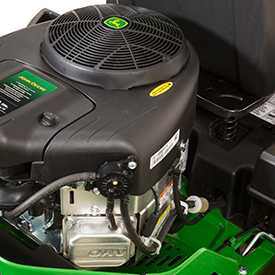 20-hp (14.9-kW) engine, left rear view
20-hp (14.9-kW) engine, left rear view
 20-hp (14.9-kW) engine, right rear view
20-hp (14.9-kW) engine, right rear view
A 20-hp (14.9-kW) V-twin engine provides plenty of power and torque to handle tough mulching, mowing, and bagging conditions:
- V-twin cylinder design for greater torque, lower vibration, and improved sound quality
- Engine model M40
- Electronic ignition for fast starts
- Cast-iron sleeves for longer engine life
- Overhead valves for excellent power and fuel economy
- Full-pressure lubrication and oil filter for keeping the oil cleaner for a long engine life and extending the time between oil changes; the full-pressure lubrication system is also more effective when operating the tractor on an incline
- Easy access to the no-tools oil drain valve for oil changes
- Rear engine guard for protecting the engine and providing additional strength and integrity
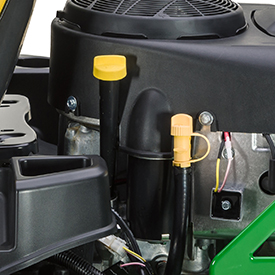 Engine oil check/fill tube and oil-drain tube
Engine oil check/fill tube and oil-drain tube
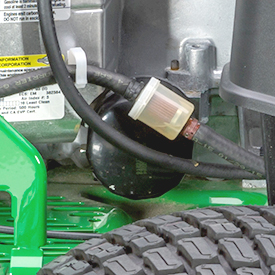 Replaceable oil filter and fuel filter
Replaceable oil filter and fuel filter
Replaceable fuel filter and oil filter are easy to access and change to minimize service time and cost.
John Deere recommends the use of fuel stabilizer in gasoline. See Fuel-Protect for gasoline engines (8 oz [237 mL]) for more information.
Operator station is designed for comfort and convenience
 Operator station (Z335E shown)
Operator station (Z335E shown)
 Color-coded controls are easy to identify
Color-coded controls are easy to identify
 Low fuel warning light illuminated
Low fuel warning light illuminated
The operator station is designed for operator comfort and convenience when operating all controls:
-
Excellent visibility forward and to the trim side of the deck makes operation easy and comfortable for the operator.
-
Controls are color coded for easy identification.
-
Low-fuel warning light is easily visible in daylight.
-
Twin-lever controls adjust, using cut-height pin/socket, for convenience and operator comfort.
-
A shock absorber dampens motion control lever movement to give smooth operation.
Comfortable seat
 Comfortable seat (Z335E shown)
Comfortable seat (Z335E shown)
 Comfortable seat (Z355E shown)
Comfortable seat (Z355E shown)
Comfortable seats make the operator experience more pleasant. Armrests, included on the Z355E seat, can be flipped up out of the way, if desired:
-
Z335E – 15-in. (38-cm) high seat back without armrests
-
Z355E – 15-in. (38-cm) high seat back with adjustable armrests
 Comfortable seat (Z345M shown)
Comfortable seat (Z345M shown)
- Z335M and Z345M – 18-in. (46-cm) high seat back with adjustable armrests
Seat suspension
 Seat suspension springs
Seat suspension springs
 Making seat fore-aft adjustment (Z335E)
Making seat fore-aft adjustment (Z335E)
Two steel coil suspension springs under the seat absorb shocks when traveling over rougher areas to provide a smoother ride.
The seat has a 2.5-in. (6.35-cm) fore-aft adjustment. The cut-height pin/socket can be used to loosen the bolts in order to make seat adjustments.
Cup holder and storage compartments
 Cup holder
Cup holder

The cup holder is designed to hold two common cup sizes securely.
 Storage compartment with cover located under seat
Storage compartment with cover located under seat
 Open storage on left side of vehicle
Open storage on left side of vehicle
 Open storage on left side of vehicle
Open storage on left side of vehicle
Covered storage under the seat and open storage along the left side of the vehicle provide safe and secure places for the operator to keep safety equipment, a cell phone, etc.
Operator foot platform
 Comfortable operator's platform
Comfortable operator's platform

Large foot platform helps the operator remain comfortable and secure:
- Volcano grips give a secure grip.
- Raised footrests at the front of the platform provide a comfortable area for the operator's feet.
Instruments and controls are convenient and easy to use
Motion-control levers
 Operator using motion-control levers
Operator using motion-control levers
 Adjustable motion-control levers
Adjustable motion-control levers
The motion-control levers can be adjusted to two height settings and nine fore-aft settings for a total of 18 different positions:
-
Increased operator comfort
-
Adjustable for more precise control of the machine
 Shock absorber for motion-control levers
Shock absorber for motion-control levers
 Cut-height pin doubles as tracking adjustment tool
Cut-height pin doubles as tracking adjustment tool
A standard shock absorber for the motion-control levers makes maneuvering ZTrak™ Mowers easy and comfortable:
-
Shock absorber modulates the movement of control levers for smoother operation.
-
Operator can smoothly and precisely control the machine.
On-board tracking adjustment from the operator seat is quick and easy. The cut-height pin includes a 13-mm wrench and doubles as a convenient tool for adjusting tracking and the motion-control lever position.
Control panel
 Control panel (Z335E shown)
Control panel (Z335E shown)
 Low fuel warning light illuminated
Low fuel warning light illuminated
The operator control panel is conveniently located and easy to use. The following instruments and controls are included:
- Hourmeter
- Low fuel warning light
- Ignition switch
- Power take-off (PTO) control
- Engine speed/choke control
- A choke position is built into the engine speed control.
Park brake
 Park brake
Park brake
The park brake is conveniently located:
- Large lever is easy to use.
- Lever is color-coded for easy identification.
- Park brake effectively holds the machine in the parked position.
- Park brake must be engaged (in the upper position) to start the engine.
- Once the engine is started, the park brake must be disengaged before operating the motion-control levers.
Mower deck lift/cut-height adjustment
 Mower deck lift/cut-height adjustment
Mower deck lift/cut-height adjustment
 Mower deck lift/cut-height adjustment in place
Mower deck lift/cut-height adjustment in place
- Mower deck cutting height adjusts from 1 in. (2.5 cm) to 4 in. (10.2 cm) in 0.25-in. (0.64-cm) increments for excellent cut quality and performance.
- Mower deck adjustment has built-in memory so the operator can easily return to the desired cutting height after raising the deck.
Serviceability is designed-in for convenience
 Service interval decal (Z300 Series shown)
Service interval decal (Z300 Series shown)
 Service interval decal (Z500 Series shown)
Service interval decal (Z500 Series shown)
A convenient service interval decal provides basic maintenance information. It provides a quick-reference for keeping recommended service up to date.
Mower deck access
 Footrest easily removed for access to mower (Z335E shown)
Footrest easily removed for access to mower (Z335E shown)
 Footrest removal bolt and hand grip (Z335E shown)
Footrest removal bolt and hand grip (Z335E shown)
The footrest area is hinged and easily raised for service to mower deck:
- It is necessary to remove just one bolt that can be conveniently removed with the lift-height pin.
-
Easy to clean grass off the top of the mower
-
Provides convenient access to the mower drive
 Loosening bolt to remove platform for access to mower deck
Loosening bolt to remove platform for access to mower deck
 Footrest opens for access to mower deck
Footrest opens for access to mower deck
Engine service
 Z335E engine
Z335E engine
 Z335E engine oil and fuel filters shown
Z335E engine oil and fuel filters shown
 Z535M and Z535R engine
Z535M and Z535R engine
 Z540M and Z540R engine
Z540M and Z540R engine
 Easy-to-access oil filter, fill/check oil tube, and oil drain
Easy-to-access oil filter, fill/check oil tube, and oil drain
The engines are easy to service, including changing the oil and the oil filter and servicing the air filter.
 Accel Deep Mower Deck
Accel Deep Mower Deck
 Tie-down locations
Tie-down locations
Accel Deep™ Mower Decks have several features that make them easy to service:
- Flat-top design minimizes places for debris to collect.
- Spring-loaded, flip-up belt guards make removing debris easy.
- Provision is provided for a standard, 3/8-in. (9.5-mm) ratchet wrench to be used for releasing belt tension when removing the drive belt.
Tie-down locations are provided for convenience and safety when trailering the machine.
The 42-in. (107-cm) Accel Deep™ (42A) Mower Deck cuts clean and is versatile
 Z335E ZTrak™ with Accel Deep 42A Mower
Z335E ZTrak™ with Accel Deep 42A Mower
 Accel Deep 42A Mower
Accel Deep 42A Mower
The 42-in. (107-cm) Accel Deep Mower Deck is a stamped-steel, deep, flat-top design that delivers excellent cut quality, productivity, cleanliness, durability, and versatility. Optimal performance and dispersion of clippings is provided, even at faster mowing speeds:
- 4.5-in. (11.4-cm) deep throughout the entire deck shell for optimum mowing, mulching, and bagging performance
- Optional MulchControl™ attachment for superior mulching performance and versatility
- Stamped-steel design eliminates sharp edges and corners where material can build up and diminish mowing performance
- Mower deck suspended from the vehicle for a smooth and level cut
- Adjustable mower wheels, positioned just above ground level, for reduced scalping
Excellent cut quality
 42A Mower top (similar mower from X300 Series Tractor shown)
42A Mower top (similar mower from X300 Series Tractor shown)
 42A Mower underside (similar mower from X300 Series Tractor shown)
42A Mower underside (similar mower from X300 Series Tractor shown)
Deep mower-deck stamping gives excellent cut quality. It allows the cut and suspended material room to exit the deck without getting recut:
- Reducing the amount of recutting enables more power to be used to cut incoming grass, which greatly improves mower capacity.
- Helps maintain excellent cut quality at faster mowing speeds
- Clean flow of material out of discharge area prevents cut material from interfering with cutting the incoming grass, making it possible for the blades to cut incoming material cleanly.
- Even in mulching mode, cut evenness is improved compared to other designs because the additional depth allows for continuous circulation, optimal recutting, and an even distribution of clippings.
Productivity - gets the job done fast
 Side-discharge chute on Accel Deep 42A Mower Deck
Side-discharge chute on Accel Deep 42A Mower Deck
Deep mower-deck stamping gives high productivity, which gets the job done fast. It allows the cut and suspended material room to exit the deck quickly, reducing the amount of re-cutting so more power is available to process incoming grass:
- Greatly improves the mower's capacity to maintain excellent mowing performance in difficult mowing conditions and at higher speeds
Large discharge opening is both high and wide to handle more material:
- Gives a smooth, even discharge of clippings at all mowing speeds
- Reduces the chance of plugging, especially important when operating in wet, thick, or dense grass and when bagging
- Cut-and-throw chute has a large, optimized inlet which aids in collecting material by using airflow from the large deck opening
Cleanliness - for the mower and the operator
 Accel Deep 42A Mower Deck
Accel Deep 42A Mower Deck
 Accel Deep 42A Mower Deck
Accel Deep 42A Mower Deck
The flat-top shape of the deck stamping is optimal for keeping itself and the operator clean:
- There are few places to catch and hold material on the top and underneath the deck.
- Top of deck stays cleaner, reducing time and effort needed for cleaning and service
- Underside of deck is self-cleaning to maintain optimum performance without build-up of material to interfere with the flow of air and clippings
- Less need to clean and remove build-up of material from underside deck
- The depth of the Accel Deep Mower Deck minimizes the amount of material that escapes from the front of the deck
- Limited amount of material to drift onto the operator and mower deck
- Even flow of material discharged out the chute, less re-cutting results in larger pieces that are less likely to end up on the operator
- Mulching prevents the discharge of material completely
- Versatility of MulchControl attachment makes mulching a practical solution for most mowing situations
Cleaning a mower deck, both top and bottom, is one of the most frequent maintenance activities:
- The flat-top design reduces places for material to build up and makes material that does collect easy to remove.
 Mower wash port
Mower wash port
 Mower wash port with hose connector
Mower wash port with hose connector
A wash port is provided to make cleaning the underside of the mower deck easy.
- Hose connector is included with the mower deck.
Superior durability is designed in
 Spindle pockets on the 42A Mower
Spindle pockets on the 42A Mower
 Mower wheels are double-captured
Mower wheels are double-captured
The 42A Mower Deck has strong spindle pockets, to keep the blades aligned, even after years of tough service:
- Ribs in the deck shell add strength where it is needed.
- The 42A has a 16 percent heavier overall weight than the Edge™ Xtra 42-in. (107-cm) Mower Deck that it replaces.
Mower wheels are double-captured:
- Provides greater strength and durability for longer, trouble-free life.
- Single-bolt adjustment makes setting wheels to the correct height for the cutting height quick and easy.
Low-tension belt-drive design reduces the side load on the engines lower bearing and mower deck bearings for longer life.
Rolled outer edge of the deck provides extra strength and protection.
Dual-stage E-coat and powder-paint coatings provide extra protection from rust.
Versatility - easy to change between side discharge, mulch, and bagging modes
 Rear MulchControl baffle (A) that must be removed for bagging
Rear MulchControl baffle (A) that must be removed for bagging
 Rear MulchControl baffle removed to allow for chute installation (Mower shown on X330 Tractor)
Rear MulchControl baffle removed to allow for chute installation (Mower shown on X330 Tractor)
The 42A Mower is designed for maximum versatility, providing the greatest ease in changing from one mower discharge mode to another:
- The mower's cut-and-throw design allows bagging with just the addition of the bagger chute, once the special bagging blades have been installed.
- The 42A cut-and-throw chute is easy to install and securely held in place at the front and rear to provide a tight seal between the mower deck and the chute.
- The rear latch is adjustable to allow for the optimum setting for easy use and a tight seal.
- The bagging blades can be used for side discharging also.
- The 42A cut-and-throw chute is easy to install and securely held in place at the front and rear to provide a tight seal between the mower deck and the chute.
- With the optional MulchControl attachment installed (along with the special mulching blades), changing from side-discharge to mulching or vice versa is done with the simple flip of a lever.
- The rear bagger can be used with the MulchControl blades installed.
- The front baffle, either the one included with the rear bagger chute or the one included with MulchControl (B), can remain in place for side discharging.
- For ultimate side-discharge performance this baffle can be removed.
- The optional MulchControl attachment includes a rear MulchControl baffle (A), held in place by two carriage bolts, at the rear edge of the discharge opening. This baffle:
- Must be removed for installation of the rear bagger chute, a 13-mm (0.51-in.) wrench is required (the bagger chute cannot be installed without removing this baffle)
- Can remain removed for side discharging material
- Must be re-installed for mulching
MulchControl option
The MulchControl attachment for the 42A Mower Deck makes mulching more practical for many mowing situations because it not only does an excellent job of mulching but it also allows the mower to be easily converted for times when it is more desirable to side discharge or collect the lawn material. Advantages of mulching grass clippings include:
- A beautiful looking lawn
- Grass clippings not blown onto the operator, driveways, or flower beds
- Less fertilizer use
- Elimination of the effort needed to dispose of clippings
How MulchControl works
 MulchControl baffle open
MulchControl baffle open
 MulchControl baffle closed
MulchControl baffle closed
MulchControl is an innovative, simple design that is easy to use and maintain:
- The MulchControl attachment includes baffles to control the flow of material under the deck.
- When the MulchControl baffle is open, most of the material passes through the discharge opening.
- When the MulchControl baffle is closed, the material stays within the deck and gets chopped into mulch and deposited in the turf.
 MulchControl baffle closed
MulchControl baffle closed
 MulchControl handle
MulchControl handle
- The MulchControl handle is located on top of the mower deck and used to open and close the discharge baffle.
- The operator is required to get off of the machine in order to engage or disengage mulch mode.
- Changing from mulching to side discharge or vice versa takes only a few seconds.
MulchControl is well-suited to the following mowing situations:
- Usually mulch, but side discharge when grass gets too long
- Usually side-discharge, but would like to be able to close the chute to control clippings
- Always mulch a main lawn, but often side discharge secondary lawns
- Bag clippings, but want to go farther before emptying bags
While in the side-discharge mode, MulchControl will still mulch about one third of the material. Therefore, the side-discharge mode is essentially a partial-mulch mode. This can be an advantage when side discharging or bagging, as it helps to reduce the amount of material being discharged. Other times this could work as a disadvantage:
- When cutting strong southern grasses, such as Zoysia and Bermuda
- When cutting in wet, high-growth conditions, such as those found in the Pacific Northwest United States
- When optimum bagging and lawn clean-up is desired
6.5-bu (230-L) rear bagger
 Z335E equipped with optional rear bagger
Z335E equipped with optional rear bagger
An optional 6.5-bu (230-L) cut-and-throw rear bagger material collection system (MCS) is available for use with the 42-in. (107-cm) Accel Deep Mower. It provides an efficient means of collecting grass clippings and leaves.
The hopper design provides modern styling, great bagging performance, cleaner operation, and easy-to-empty bags:
- 6.5-bu (230-L) capacity
- Easy-to-attach lower chute
- Air exhaust duct
- Convenient spring-latch
- Airflow fill indicator
- Quik-Tatch mounting
- Sealed hopper top
- Loose-knit bags available
Mower blades
 Mower blades shipped with the rear bagger
Mower blades shipped with the rear bagger
High-lift bagging blades are included with the chute. They provide optimum performance when bagging in difficult conditions, such as when the grass is moist, dense, or long:
- High-lift bagging blades also work well when side discharging material.
Mulching blades are included with the MulchControl attachment. They can be used for mulching, side discharging, and bagging in most conditions.
Mower blade use chart
| Mode(s) of operation | Mower blade |
| Side discharging mode only | M170639 side-discharge blade (shipped with mower) |
| Bagging mode only | GX25668 bagging blade (shipped with BG20754 rear bagger chute) |
| Mulching mode only | M170642 mulching blade (shipped with BM24794 MulchControl) |
| Side discharge and mulching | M170642 mulching blade (shipped with BM24794 MulchControl) |
| Side discharge and bagging | GX25668 bagging blade (shipped with BG20754 rear bagger chute) |
| Side discharge, mulching, and bagging | M170642 mulching blade (shipped with BM24794 MulchControl) |
Features
Design includes a heavy-duty formed and welded steel frame
 ZTrak™ Z335E shown
ZTrak™ Z335E shown
 ZTrak Z535M shown
ZTrak Z535M shown
ZTrak Mowers are designed around a heavy-duty formed and welded steel frame for strength and reliability.
Large front caster wheels and large rear drive wheels provide several operator benefits:
-
Smoother ride
-
Better slope performance
-
More operator comfort over uneven ground
-
Better traction
The operator platform is roomy and uncluttered for maximum comfort, and the controls are convenient to use:
- Easy to get on and off the mower
- Ample legroom for comfortable operation
- Adjustable motion-control levers for height and position, enabling the operator to stay comfortable while using them
- Color-coded and logically placed controls
Engine is smooth and powerful V-twin design
 20-hp (14.9-kW) engine, left rear view
20-hp (14.9-kW) engine, left rear view
 20-hp (14.9-kW) engine, right rear view
20-hp (14.9-kW) engine, right rear view
A 20-hp (14.9-kW) V-twin engine provides plenty of power and torque to handle tough mulching, mowing, and bagging conditions:
- V-twin cylinder design for greater torque, lower vibration, and improved sound quality
- Engine model M40
- Electronic ignition for fast starts
- Cast-iron sleeves for longer engine life
- Overhead valves for excellent power and fuel economy
- Full-pressure lubrication and oil filter for keeping the oil cleaner for a long engine life and extending the time between oil changes; the full-pressure lubrication system is also more effective when operating the tractor on an incline
- Easy access to the no-tools oil drain valve for oil changes
- Rear engine guard for protecting the engine and providing additional strength and integrity
 Engine oil check/fill tube and oil-drain tube
Engine oil check/fill tube and oil-drain tube
 Replaceable oil filter and fuel filter
Replaceable oil filter and fuel filter
Replaceable fuel filter and oil filter are easy to access and change to minimize service time and cost.
John Deere recommends the use of fuel stabilizer in gasoline. See Fuel-Protect for gasoline engines (8 oz [237 mL]) for more information.
Operator station is designed for comfort and convenience
 Operator station (Z335E shown)
Operator station (Z335E shown)
 Color-coded controls are easy to identify
Color-coded controls are easy to identify
 Low fuel warning light illuminated
Low fuel warning light illuminated
The operator station is designed for operator comfort and convenience when operating all controls:
-
Excellent visibility forward and to the trim side of the deck makes operation easy and comfortable for the operator.
-
Controls are color coded for easy identification.
-
Low-fuel warning light is easily visible in daylight.
-
Twin-lever controls adjust, using cut-height pin/socket, for convenience and operator comfort.
-
A shock absorber dampens motion control lever movement to give smooth operation.
Comfortable seat
 Comfortable seat (Z335E shown)
Comfortable seat (Z335E shown)
 Comfortable seat (Z355E shown)
Comfortable seat (Z355E shown)
Comfortable seats make the operator experience more pleasant. Armrests, included on the Z355E seat, can be flipped up out of the way, if desired:
-
Z335E – 15-in. (38-cm) high seat back without armrests
-
Z355E – 15-in. (38-cm) high seat back with adjustable armrests
 Comfortable seat (Z345M shown)
Comfortable seat (Z345M shown)
- Z335M and Z345M – 18-in. (46-cm) high seat back with adjustable armrests
Seat suspension
 Seat suspension springs
Seat suspension springs
 Making seat fore-aft adjustment (Z335E)
Making seat fore-aft adjustment (Z335E)
Two steel coil suspension springs under the seat absorb shocks when traveling over rougher areas to provide a smoother ride.
The seat has a 2.5-in. (6.35-cm) fore-aft adjustment. The cut-height pin/socket can be used to loosen the bolts in order to make seat adjustments.
Cup holder and storage compartments
 Cup holder
Cup holder

The cup holder is designed to hold two common cup sizes securely.
 Storage compartment with cover located under seat
Storage compartment with cover located under seat
 Open storage on left side of vehicle
Open storage on left side of vehicle
 Open storage on left side of vehicle
Open storage on left side of vehicle
Covered storage under the seat and open storage along the left side of the vehicle provide safe and secure places for the operator to keep safety equipment, a cell phone, etc.
Operator foot platform
 Comfortable operator's platform
Comfortable operator's platform

Large foot platform helps the operator remain comfortable and secure:
- Volcano grips give a secure grip.
- Raised footrests at the front of the platform provide a comfortable area for the operator's feet.
Instruments and controls are convenient and easy to use
Motion-control levers
 Operator using motion-control levers
Operator using motion-control levers
 Adjustable motion-control levers
Adjustable motion-control levers
The motion-control levers can be adjusted to two height settings and nine fore-aft settings for a total of 18 different positions:
-
Increased operator comfort
-
Adjustable for more precise control of the machine
 Shock absorber for motion-control levers
Shock absorber for motion-control levers
 Cut-height pin doubles as tracking adjustment tool
Cut-height pin doubles as tracking adjustment tool
A standard shock absorber for the motion-control levers makes maneuvering ZTrak™ Mowers easy and comfortable:
-
Shock absorber modulates the movement of control levers for smoother operation.
-
Operator can smoothly and precisely control the machine.
On-board tracking adjustment from the operator seat is quick and easy. The cut-height pin includes a 13-mm wrench and doubles as a convenient tool for adjusting tracking and the motion-control lever position.
Control panel
 Control panel (Z335E shown)
Control panel (Z335E shown)
 Low fuel warning light illuminated
Low fuel warning light illuminated
The operator control panel is conveniently located and easy to use. The following instruments and controls are included:
- Hourmeter
- Low fuel warning light
- Ignition switch
- Power take-off (PTO) control
- Engine speed/choke control
- A choke position is built into the engine speed control.
Park brake
 Park brake
Park brake
The park brake is conveniently located:
- Large lever is easy to use.
- Lever is color-coded for easy identification.
- Park brake effectively holds the machine in the parked position.
- Park brake must be engaged (in the upper position) to start the engine.
- Once the engine is started, the park brake must be disengaged before operating the motion-control levers.
Mower deck lift/cut-height adjustment
 Mower deck lift/cut-height adjustment
Mower deck lift/cut-height adjustment
 Mower deck lift/cut-height adjustment in place
Mower deck lift/cut-height adjustment in place
- Mower deck cutting height adjusts from 1 in. (2.5 cm) to 4 in. (10.2 cm) in 0.25-in. (0.64-cm) increments for excellent cut quality and performance.
- Mower deck adjustment has built-in memory so the operator can easily return to the desired cutting height after raising the deck.
Serviceability is designed-in for convenience
 Service interval decal (Z300 Series shown)
Service interval decal (Z300 Series shown)
 Service interval decal (Z500 Series shown)
Service interval decal (Z500 Series shown)
A convenient service interval decal provides basic maintenance information. It provides a quick-reference for keeping recommended service up to date.
Mower deck access
 Footrest easily removed for access to mower (Z335E shown)
Footrest easily removed for access to mower (Z335E shown)
 Footrest removal bolt and hand grip (Z335E shown)
Footrest removal bolt and hand grip (Z335E shown)
The footrest area is hinged and easily raised for service to mower deck:
- It is necessary to remove just one bolt that can be conveniently removed with the lift-height pin.
-
Easy to clean grass off the top of the mower
-
Provides convenient access to the mower drive
 Loosening bolt to remove platform for access to mower deck
Loosening bolt to remove platform for access to mower deck
 Footrest opens for access to mower deck
Footrest opens for access to mower deck
Engine service
 Z335E engine
Z335E engine
 Z335E engine oil and fuel filters shown
Z335E engine oil and fuel filters shown
 Z535M and Z535R engine
Z535M and Z535R engine
 Z540M and Z540R engine
Z540M and Z540R engine
 Easy-to-access oil filter, fill/check oil tube, and oil drain
Easy-to-access oil filter, fill/check oil tube, and oil drain
The engines are easy to service, including changing the oil and the oil filter and servicing the air filter.
 Accel Deep Mower Deck
Accel Deep Mower Deck
 Tie-down locations
Tie-down locations
Accel Deep™ Mower Decks have several features that make them easy to service:
- Flat-top design minimizes places for debris to collect.
- Spring-loaded, flip-up belt guards make removing debris easy.
- Provision is provided for a standard, 3/8-in. (9.5-mm) ratchet wrench to be used for releasing belt tension when removing the drive belt.
Tie-down locations are provided for convenience and safety when trailering the machine.
The 42-in. (107-cm) Accel Deep™ (42A) Mower Deck cuts clean and is versatile
 Z335E ZTrak™ with Accel Deep 42A Mower
Z335E ZTrak™ with Accel Deep 42A Mower
 Accel Deep 42A Mower
Accel Deep 42A Mower
The 42-in. (107-cm) Accel Deep Mower Deck is a stamped-steel, deep, flat-top design that delivers excellent cut quality, productivity, cleanliness, durability, and versatility. Optimal performance and dispersion of clippings is provided, even at faster mowing speeds:
- 4.5-in. (11.4-cm) deep throughout the entire deck shell for optimum mowing, mulching, and bagging performance
- Optional MulchControl™ attachment for superior mulching performance and versatility
- Stamped-steel design eliminates sharp edges and corners where material can build up and diminish mowing performance
- Mower deck suspended from the vehicle for a smooth and level cut
- Adjustable mower wheels, positioned just above ground level, for reduced scalping
Excellent cut quality
 42A Mower top (similar mower from X300 Series Tractor shown)
42A Mower top (similar mower from X300 Series Tractor shown)
 42A Mower underside (similar mower from X300 Series Tractor shown)
42A Mower underside (similar mower from X300 Series Tractor shown)
Deep mower-deck stamping gives excellent cut quality. It allows the cut and suspended material room to exit the deck without getting recut:
- Reducing the amount of recutting enables more power to be used to cut incoming grass, which greatly improves mower capacity.
- Helps maintain excellent cut quality at faster mowing speeds
- Clean flow of material out of discharge area prevents cut material from interfering with cutting the incoming grass, making it possible for the blades to cut incoming material cleanly.
- Even in mulching mode, cut evenness is improved compared to other designs because the additional depth allows for continuous circulation, optimal recutting, and an even distribution of clippings.
Productivity - gets the job done fast
 Side-discharge chute on Accel Deep 42A Mower Deck
Side-discharge chute on Accel Deep 42A Mower Deck
Deep mower-deck stamping gives high productivity, which gets the job done fast. It allows the cut and suspended material room to exit the deck quickly, reducing the amount of re-cutting so more power is available to process incoming grass:
- Greatly improves the mower's capacity to maintain excellent mowing performance in difficult mowing conditions and at higher speeds
Large discharge opening is both high and wide to handle more material:
- Gives a smooth, even discharge of clippings at all mowing speeds
- Reduces the chance of plugging, especially important when operating in wet, thick, or dense grass and when bagging
- Cut-and-throw chute has a large, optimized inlet which aids in collecting material by using airflow from the large deck opening
Cleanliness - for the mower and the operator
 Accel Deep 42A Mower Deck
Accel Deep 42A Mower Deck
 Accel Deep 42A Mower Deck
Accel Deep 42A Mower Deck
The flat-top shape of the deck stamping is optimal for keeping itself and the operator clean:
- There are few places to catch and hold material on the top and underneath the deck.
- Top of deck stays cleaner, reducing time and effort needed for cleaning and service
- Underside of deck is self-cleaning to maintain optimum performance without build-up of material to interfere with the flow of air and clippings
- Less need to clean and remove build-up of material from underside deck
- The depth of the Accel Deep Mower Deck minimizes the amount of material that escapes from the front of the deck
- Limited amount of material to drift onto the operator and mower deck
- Even flow of material discharged out the chute, less re-cutting results in larger pieces that are less likely to end up on the operator
- Mulching prevents the discharge of material completely
- Versatility of MulchControl attachment makes mulching a practical solution for most mowing situations
Cleaning a mower deck, both top and bottom, is one of the most frequent maintenance activities:
- The flat-top design reduces places for material to build up and makes material that does collect easy to remove.
 Mower wash port
Mower wash port
 Mower wash port with hose connector
Mower wash port with hose connector
A wash port is provided to make cleaning the underside of the mower deck easy.
- Hose connector is included with the mower deck.
Superior durability is designed in
 Spindle pockets on the 42A Mower
Spindle pockets on the 42A Mower
 Mower wheels are double-captured
Mower wheels are double-captured
The 42A Mower Deck has strong spindle pockets, to keep the blades aligned, even after years of tough service:
- Ribs in the deck shell add strength where it is needed.
- The 42A has a 16 percent heavier overall weight than the Edge™ Xtra 42-in. (107-cm) Mower Deck that it replaces.
Mower wheels are double-captured:
- Provides greater strength and durability for longer, trouble-free life.
- Single-bolt adjustment makes setting wheels to the correct height for the cutting height quick and easy.
Low-tension belt-drive design reduces the side load on the engines lower bearing and mower deck bearings for longer life.
Rolled outer edge of the deck provides extra strength and protection.
Dual-stage E-coat and powder-paint coatings provide extra protection from rust.
Versatility - easy to change between side discharge, mulch, and bagging modes
 Rear MulchControl baffle (A) that must be removed for bagging
Rear MulchControl baffle (A) that must be removed for bagging
 Rear MulchControl baffle removed to allow for chute installation (Mower shown on X330 Tractor)
Rear MulchControl baffle removed to allow for chute installation (Mower shown on X330 Tractor)
The 42A Mower is designed for maximum versatility, providing the greatest ease in changing from one mower discharge mode to another:
- The mower's cut-and-throw design allows bagging with just the addition of the bagger chute, once the special bagging blades have been installed.
- The 42A cut-and-throw chute is easy to install and securely held in place at the front and rear to provide a tight seal between the mower deck and the chute.
- The rear latch is adjustable to allow for the optimum setting for easy use and a tight seal.
- The bagging blades can be used for side discharging also.
- The 42A cut-and-throw chute is easy to install and securely held in place at the front and rear to provide a tight seal between the mower deck and the chute.
- With the optional MulchControl attachment installed (along with the special mulching blades), changing from side-discharge to mulching or vice versa is done with the simple flip of a lever.
- The rear bagger can be used with the MulchControl blades installed.
- The front baffle, either the one included with the rear bagger chute or the one included with MulchControl (B), can remain in place for side discharging.
- For ultimate side-discharge performance this baffle can be removed.
- The optional MulchControl attachment includes a rear MulchControl baffle (A), held in place by two carriage bolts, at the rear edge of the discharge opening. This baffle:
- Must be removed for installation of the rear bagger chute, a 13-mm (0.51-in.) wrench is required (the bagger chute cannot be installed without removing this baffle)
- Can remain removed for side discharging material
- Must be re-installed for mulching
MulchControl option
The MulchControl attachment for the 42A Mower Deck makes mulching more practical for many mowing situations because it not only does an excellent job of mulching but it also allows the mower to be easily converted for times when it is more desirable to side discharge or collect the lawn material. Advantages of mulching grass clippings include:
- A beautiful looking lawn
- Grass clippings not blown onto the operator, driveways, or flower beds
- Less fertilizer use
- Elimination of the effort needed to dispose of clippings
How MulchControl works
 MulchControl baffle open
MulchControl baffle open
 MulchControl baffle closed
MulchControl baffle closed
MulchControl is an innovative, simple design that is easy to use and maintain:
- The MulchControl attachment includes baffles to control the flow of material under the deck.
- When the MulchControl baffle is open, most of the material passes through the discharge opening.
- When the MulchControl baffle is closed, the material stays within the deck and gets chopped into mulch and deposited in the turf.
 MulchControl baffle closed
MulchControl baffle closed
 MulchControl handle
MulchControl handle
- The MulchControl handle is located on top of the mower deck and used to open and close the discharge baffle.
- The operator is required to get off of the machine in order to engage or disengage mulch mode.
- Changing from mulching to side discharge or vice versa takes only a few seconds.
MulchControl is well-suited to the following mowing situations:
- Usually mulch, but side discharge when grass gets too long
- Usually side-discharge, but would like to be able to close the chute to control clippings
- Always mulch a main lawn, but often side discharge secondary lawns
- Bag clippings, but want to go farther before emptying bags
While in the side-discharge mode, MulchControl will still mulch about one third of the material. Therefore, the side-discharge mode is essentially a partial-mulch mode. This can be an advantage when side discharging or bagging, as it helps to reduce the amount of material being discharged. Other times this could work as a disadvantage:
- When cutting strong southern grasses, such as Zoysia and Bermuda
- When cutting in wet, high-growth conditions, such as those found in the Pacific Northwest United States
- When optimum bagging and lawn clean-up is desired
6.5-bu (230-L) rear bagger
 Z335E equipped with optional rear bagger
Z335E equipped with optional rear bagger
An optional 6.5-bu (230-L) cut-and-throw rear bagger material collection system (MCS) is available for use with the 42-in. (107-cm) Accel Deep Mower. It provides an efficient means of collecting grass clippings and leaves.
The hopper design provides modern styling, great bagging performance, cleaner operation, and easy-to-empty bags:
- 6.5-bu (230-L) capacity
- Easy-to-attach lower chute
- Air exhaust duct
- Convenient spring-latch
- Airflow fill indicator
- Quik-Tatch mounting
- Sealed hopper top
- Loose-knit bags available
Mower blades
 Mower blades shipped with the rear bagger
Mower blades shipped with the rear bagger
High-lift bagging blades are included with the chute. They provide optimum performance when bagging in difficult conditions, such as when the grass is moist, dense, or long:
- High-lift bagging blades also work well when side discharging material.
Mulching blades are included with the MulchControl attachment. They can be used for mulching, side discharging, and bagging in most conditions.
Mower blade use chart
| Mode(s) of operation | Mower blade |
| Side discharging mode only | M170639 side-discharge blade (shipped with mower) |
| Bagging mode only | GX25668 bagging blade (shipped with BG20754 rear bagger chute) |
| Mulching mode only | M170642 mulching blade (shipped with BM24794 MulchControl) |
| Side discharge and mulching | M170642 mulching blade (shipped with BM24794 MulchControl) |
| Side discharge and bagging | GX25668 bagging blade (shipped with BG20754 rear bagger chute) |
| Side discharge, mulching, and bagging | M170642 mulching blade (shipped with BM24794 MulchControl) |
Features
Engine
- Features an EPA Final Tier 4 (FT4)/Stage IV engine that is simple, fully integrated, and fully supported to deliver industry-leading fuel efficiency and uptime.
Cab & Controls
- Easy-to-operate controls maximize an operator’s skills, for more everyday productivity.
- Spacious, comfortable cab is even more tightly sealed to keep out noise and dust. Available options include a four-season cab, Bluetooth® radio, and heated seats.
- Excellent all-around visibility has been further enhanced with customer-inspired side lighting and rearview camera options.
Productivity
- Industry-leading bucket breakout forces and auxiliary flow
- The 324G’s height to hinge pin is 10 ft. 6 in. to easily load high-sidewall dump trucks, feed mixers, and hoppers.
Uptime
- Easy Maintenance: Cab foot-well area can be washed out in a matter of minutes. Glove-friendly removable side windows make cleaning easier.
- Optional JDLink™ provides machine data and health alerts to help you decrease costly downtime.
Features
Engine
- Features an EPA Final Tier 4 (FT4)/Stage IV engine that is simple, fully integrated, and fully supported to deliver industry-leading fuel efficiency and uptime.
Cab & Controls
- Easy-to-operate controls maximize an operator’s skills, for more everyday productivity.
- Spacious, comfortable cab is even more tightly sealed to keep out noise and dust. Available options include a four-season cab, Bluetooth® radio, and heated seats.
- Excellent all-around visibility has been further enhanced with customer-inspired side lighting and rearview camera options.
- Redesigned cab features an improved door seal with integrated chinstrap and glove-friendly removable side windows.
Productivity
- Industry-leading bucket breakout forces and auxiliary flow
Uptime
- Easy Maintenance: Cab foot-well area can be washed out in a matter of minutes. Glove-friendly removable side windows make cleaning easier.
- Optional JDLink™ provides machine data and health alerts to help you decrease costly downtime.
Features
PowerTech™ PSS cooled exhaust gas recirculation (EGR)
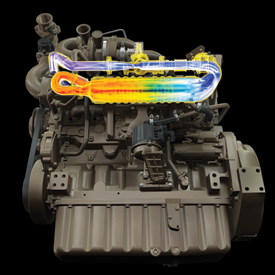 PowerTech PSS 9.0L engine
PowerTech PSS 9.0L engine
The John Deere exhaust filter is integrated into the engine design and electronics to provide a seamless operator experience. The engine control unit (ECU) and exhaust temperature management (ETM) system work together to continuously regenerate the exhaust filter using a natural cleaning process sometimes referred to as passive regeneration.
If natural filter cleaning cannot be achieved based on temperature, load, and speed, then particulate matter (PM) must be removed using an automatic cleaning process sometimes referred to as active regeneration. In most cases, filter cleaning does not impact machine operation or require operator involvement. Higher pressures created by our Final Tier 4 (FT4)/Stage IV high-pressure fuel system extend intervals between automatic cleanings.
How EGR works
EGR reduces the high temperatures where nitrogen oxide (NOx) compounds are formed in the engine cylinders by replacing excess oxygen with a prescribed amount of cooled exhaust gas.
Exhaust gases contain more carbon dioxide than oxygen. The EGR valve, in conjunction with the venturi and ECU, allows a controlled amount of exhaust gas to enter the intake manifold to mix with the incoming fresh air. Replacing excess oxygen with cooled exhaust gas leads to lower combustion temperatures, creating less NOx. In addition, EGR allows for advanced timing, leading to optimal performance of the engine, maximizing fuel economy.
Flow of exhaust during engine operation
Exhaust airflow enters into the EGR cooler from the exhaust manifold near the turbocharger.
Based on engine load, air temperatures, and rpm, the ECU opens or closes the EGR valve, allowing a measured percentage of exhaust gas to enter the intake manifold.
The gases mix with the rest of the incoming air from the turbocharger and aftercooler before entering the cylinders.
The following diagrams illustrate how air flows through the engine (PSS).
For added performance and efficiency, the engine passes the exhaust gases through an EGR cooler before it enters the engine.
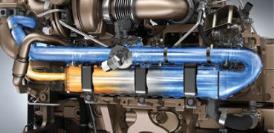 PSS EGR
PSS EGR
PSS 9.0L and 13.5L FT4 technology
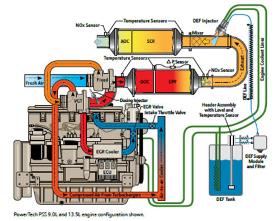 PowerTech PSS Final Tier 4 technology
PowerTech PSS Final Tier 4 technology
Standard CommandView™ III cab offers unsurpassed amenities
 CommandView III cab
CommandView III cab
The standard CommandView III cab offers unsurpassed visibility, operator comfort, control placement, and ride and sound quality.
Features:
- ComfortCommand™ seat with air suspension, lumbar support, swivel, fore-aft and lateral attenuation, backrest angle adjustment, adjustable left-hand armrest, and 40-degree right-hand seat swivel
- Operator presence system that warns if the operator is out of the seat while operating key functions
- Folding instructional seat
- CommandARM™ control center with integrated controls
- 4100 or 4600 Generation 4 CommandCenter™ processor
- Behind-the-seat storage
- Left-hand storage compartment
- Passive noise reduction system
- Service ADVISOR™ diagnostic system data port
- Tilt/telescoping steering wheel with position memory
- Swing-out rear window, opens 30 degrees
- Right- and left-outside mirrors (manually adjustable mirror head)
- Monitor mounts on right-hand front post and rear cab post
- Standard radio package, including AM/FM stereo and weatherband with remote controls, auxiliary input jack, four speakers, and an external antenna
- Laminated glass
- Air conditioner and heater with automatic temperature controls (ATC)
- Two 12-V convenience outlet (cigarette lighter style)
- One 12-V 3-pin outlet with adapter (provides switched and unswitched power)
- One International Organization for Standardization (ISO) nine-pin connector
- Power strip with convenience plug adapter
- Hitch control lever lock and selective control lever lock
- Two-speed and intermittent front and rear wiper with washer
- Front pull-down sunshade
- Digital cornerpost display with:
- Fuel level gauge, including low fuel warning
- Temperature gauge
- Diesel exhaust fluid (DEF) gauge, including low DEF warning
- Engine rpm
- Transmission commanded gear or speed
- Vehicle system functions, such as iTEC™ end-row guidance, that are operating
- Inside-mounted rearview mirror
- Beverage holders sized to accommodate various containers
- Interior left-hand dome light
ComfortCommand seat
 ComfortCommand seat
ComfortCommand seat
ComfortCommand seat improves ride quality and helps to reduce operator fatigue
Features include:
- Armrests, lumbar support, and backrest angle are easily adjusted to match operator preference.
- Shock absorbers dampen the motion effect of the tractor for an improved ride.
- Seat height adjustments are conveniently located on the left armrest.
- Fore-aft adjustment is easy to reach located on the left front of the seat.
- Swivel adjustment, located on the front of the seat, allows the seat to be swiveled 40 degrees to the right or eight degrees to the left of the center position.
- Operator presence switch warns if the operator is out of the seat while operating key functions.
- Seat belt retractor.
- Centered cab seat, providing excellent over-shoulder visibility.
- Adjustable shock absorber permitting ride adjustment from soft to firm to match the operator's desired comfort level.
- Removable cushions for easy cleaning.
CommandARM
 CommandARM controls
CommandARM controls
John Deere 9 Family Tractors feature the CommandARM with integrated Generation 4 CommandCenter display. The control layout of the CommandARM utilizes a clean and efficient design which groups controls by function and builds upon John Deere’s history of intuitive and ergonomic control placement and operation. The design of the CommandARM allows for a 40-degree right seat swivel and adjustable positioning matching the operator’s preference.
Controls located on the CommandARM include:
- Engine throttle
- Transmission control for e18™ transmission speed PowerShift™ transmission
- Eco mode (minimum engine speed) for e18 speed PowerShift transmission
- FieldCruise™ engine controls
- Selective control valve (SCV) controls
- AutoLoad™ controls (if equipped)
- Differential lock on/off and automatic
- iTEC™ sequence switches
- AutoTrac™ assisted steering system resume switch (if equipped)
- Radio
- Beacon light on/off
- Hazard lights on/off
- Field lights 1/2
- Heating, ventilation, air-conditioning (HVAC) system
Hydraulic controls
Hydraulic controls utilize fingertip paddle pots for raise/lower and extend/retract functions.
 Fingertip paddle pots
Fingertip paddle pots
Throttle
The throttle design incorporates buttons which control FieldCruise speed, and transmission eco settings.
 Throttle
Throttle
Tractor function controls
Located just to the right of the throttle is the Auto-Trac activation button and four sequence controls for iTEC functions. Behind the iTEC sequence controls there are buttons which control the activation and deactivation of differential lock. Differential lock can also be activated by the foot switch on the cab floor.
 AutoTrac resume and iTEC strip
AutoTrac resume and iTEC strip
Controls for radio, lights, rotary beacon (if equipped), hazard flashers, and HVAC system are located to the center-right on the CommandARM, along with power take-off (PTO) for rear PTO.
 Radio, HVAC, hazard flashers, and PTO controls
Radio, HVAC, hazard flashers, and PTO controls
Seat swivel
The design of the CommandARM allows for up to 40 degrees of right-hand seat swivel.
 Seat swivel
Seat swivel
 40-degree seat swivel shown
40-degree seat swivel shown
CommandCenter
 Generation 4 CommandCenter
Generation 4 CommandCenter
The Generation 4 CommandCenters features fast adjustment of tractor functions and controls and are integrated into the CommandARM to create a seamless control center.
The following functions can be adjusted and accessed using the CommandCenter display:
- Hydraulic settings
- Hitch settings
- Transmission settings
- FieldCruise
- iTEC programming functions
- Radio
- Lights
- Add all functionality – diagnostics, display settings, etc.
The Generation 4 CommandCenter systems have the capability of Remote Display Access (RDA). RDA allows improved communication between an offsite farm manager or dealer and the equipment operator. The user can view exactly what the operator sees on the GreenStar™ 3 2630 Display and Generation 4 CommandCenter from almost any internet-connected device. RDA is available on the 4600 and 4100 CommandCenter and allows for an increase in productivity with quicker problem resolution. By using RDA, the cost of operation will decrease due to reduced labor and travel costs, and maximum efficiency will increase profit.
e18™ PowerShift™ transmission with Efficiency Manager™ feature
The e18 transmission delivers smooth shifting and intuitive controls in a reliable 18-speed PowerShift transmission. The e18 transmission with enhanced Efficiency Manager is standard equipment on all 9 Family Tractors.
The e18 has evolved from more than 50 years of John Deere PowerShift technology. With more automatic features, the e18 is easy to operate for all levels of operators and operations. It features three modes of operation, full AUTO, custom, and manual modes. Full AUTO and custom modes manage the engine and transmission to match the desired ground speed to the field conditions. These two modes are ideal for most conditions and take the guess work out of operation. Manual mode is perfect for operators looking to operate the e18 like a traditional PowerShift by bump shifting and managing the engine throttle to their liking.
As the next generation of PowerShift technology, the e18 delivers the strength to handle sudden, high-torque power loads while maintaining responsive, quick, and smooth shifts.
e18 controls
 Shift lever and hand throttle
Shift lever and hand throttle
CommandCenter™ controls
 254-mm (10-in.) Generation 4 CommandCenter
254-mm (10-in.) Generation 4 CommandCenter
The CommandCenter is the central information system for tractors and allows the operator to program various settings tailored to a specific operation.
To access the tractor’s transmission settings, press the transmission shortcut button on the CommandCenter shortcut bar.
 CommandCenter transmission shortcut button
CommandCenter transmission shortcut button
Operating modes
The e18 application settings employ three modes to take full advantage of the engine-transmission communication: Full AUTO mode, custom mode, and manual mode.
Full AUTO mode
 Full AUTO main page
Full AUTO main page
Full AUTO mode manages the tractor’s engine and transmission inputs to reach and maintain the desired ground speed set by the operator. This means the tractor will manage shifts and engine rpm to operate at the most efficient level possible. Operators have the ability to set the maximum forward and reverse speeds for their particular applications. In full AUTO mode the operator can adjust the desired ground speed in two ways, by conducting a traditional bump shift or by rotating the dial on the thumb wheel.
When shifting in full AUTO mode, the transmission shifts set speeds and does not always shift gears, meaning the transmission may not necessarily shift gears if it can reach the desired ground speed with a slightly higher or lower engine rpm. Efficiency Manager is automatically engaged while operating in full AUTO mode. As a result, shifting will not take the tractor out of Efficiency Manager in full AUTO mode.
Custom mode
 e18 custom transmission page
e18 custom transmission page
Custom mode operates similar to full AUTO mode but allows operators to adjust operating parameters to meet a specific operation. It also has the ability to activate eco mode for a higher level of operation.
 Eco button
Eco button
 Display screen
Display screen
Eco allows two minimum engine speeds to be set. Operators can turn eco on and off by either pushing the eco button on the side of the throttle or by selecting eco in the transmission settings page of the CommandCenter controls. For example, operators may choose to turn eco on during transport to utilize a lower minimum engine speed and then turn eco off while operating in the field where a higher minimum engine speed is desired.
 Custom settings page
Custom settings page
In the advanced settings page, operators can customize the auto shift engine speed droop as a percentage of the full engine speed. In addition, the load anticipation feature can be enabled for the hitch engagement, hydraulic engagement, or both.
Manual mode
Manual mode operates very similarly to a traditional PowerShift transmission with Efficiency Manager.
In manual mode the operator manages the engine and transmission inputs by controlling the shift lever and hand throttle.
 Manual mode page
Manual mode page
Efficiency Manager
 Set speed buttons and set speed adjuster
Set speed buttons and set speed adjuster
Efficiency Manager is automatically enabled in auto and custom modes. Efficiency Manager can be turned on in manual mode by selecting the set speed one or set speed two button on the CommandARM™ console. The set speed adjuster on the top of the single-lever gear selector allows the operator to dial in the desired ground speed to establish set speed one or two. Once engaged, Efficiency Manager will manage the engine rpm and gear selection to maintain the desired working speed. To reach the desired set speed, the throttle must be set to full engine rpm.
e18 operation
 e18 operation
e18 operation
Setting start-up gears
The 9 Family Tractors default to 7F and 2R at start up. However, these default start-up gears can be adjusted from 1-13F and 1-3R through the CommandCenter. Refer to the operator’s manual for additional information.
 Start-up gears in advanced settings
Start-up gears in advanced settings
9R Series Tractor - e18-speed chart for PowerShift transmission with Efficiency Manager
9R table
Group 47 tires |
Group 48 tires |
|||
Tire size |
(480R46, 20.8R42, 520R42, 620R42, 710R38) |
(480R50, 520R46, 620R46, 710R42, 800R38) |
||
Engine (rpm) |
2100 |
2100 |
||
18-speed gear |
km/h |
mph |
km/h |
mph |
Forward gears |
||||
F1 |
4.0 |
2.5 |
4.2 |
2.6 |
F2 |
4.8 |
3.0 |
5.0 |
3.1 |
F3 |
5.3 |
3.3 |
5.6 |
3.5 |
F4 |
5.9 |
3.7 |
6.2 |
3.9 |
F5 |
6.5 |
4.0 |
6.8 |
4.3 |
F6 |
7.3 |
4.5 |
7.6 |
4.8 |
F7 |
8.0 |
5.0 |
8.5 |
5.3 |
F8 |
9.0 |
5.6 |
9.5 |
5.9 |
F9 |
9.9 |
6.1 |
10.4 |
6.5 |
F10 |
11.0 |
6.9 |
11.6 |
7.2 |
F11 |
12.2 |
7.6 |
12.9 |
8.0 |
F12 |
13.5 |
8.4 |
14.2 |
8.8 |
F13 |
15.0 |
9.3 |
15.8 |
9.8 |
F14 |
16.6 |
10.3 |
17.5 |
10.9 |
F15 |
20.5 |
12.8 |
21.6 |
13.4 |
F16 |
25.3 |
15.7 |
26.6 |
16.5 |
F17 |
31.2 |
19.4 |
32.9 |
20.4 |
F18 |
38.5 |
23.9 |
40.5 |
25.2 |
Reverse gears |
||||
R1 |
3.9 |
2.4 |
4.1 |
2.5 |
R2 |
5.3 |
3.3 |
5.6 |
3.5 |
R3 |
5.9 |
3.7 |
6.2 |
3.9 |
R4 |
8.0 |
5.0 |
8.5 |
5.3 |
R5 |
9.0 |
5.6 |
9.5 |
5.9 |
R6 |
12.2 |
7.6 |
12.9 |
8.0 |
Group 47 tire based on 710/70R38
Group 48 tire based on 800/80R38
9RT and 9RX Series Tractor - e18-speed chart for PowerShift transmission with Efficiency Manager
9RT and 9RX table
|
9RT |
9RX |
||
Engine (rpm) |
2100 |
2100 |
||
18-speed gear |
km/h |
mph |
km/h |
mph |
Forward gears |
|
|
|
|
F1 |
4.0 |
2.5 |
4.0 |
2.5 |
F2 |
5.0 |
3.1 |
4.9 |
3.0 |
F3 |
5.5 |
3.4 |
5.5 |
3.4 |
F4 |
6.1 |
3.8 |
6.1 |
3.8 |
F5 |
6.8 |
4.2 |
6.7 |
4.2 |
F6 |
7.6 |
4.7 |
7.5 |
4.7 |
F7 |
8.4 |
5.2 |
8.3 |
5.2 |
F8 |
9.3 |
5.8 |
9.2 |
5.7 |
F9 |
10.3 |
6.4 |
10.2 |
6.3 |
F10 |
11.4 |
7.1 |
11.4 |
7.1 |
F11 |
12.6 |
7.8 |
12.6 |
7.8 |
F12 |
14.1 |
8.7 |
14.0 |
8.7 |
F13 |
15.6 |
9.7 |
15.5 |
9.6 |
F14 |
17.3 |
10.7 |
17.2 |
10.3 |
F15 |
21.4 |
13.3 |
21.3 |
13.2 |
F16 |
26.3 |
16.3 |
26.2 |
16.3 |
F17 |
32.3 |
20.1 |
32.2 |
20.0 |
F18 |
39.8 |
24.7 |
39.6 |
24.6 |
Reverse gears |
|
|
|
|
R1 |
4.0 |
2.5 |
4.0 |
2.5 |
R2 |
5.5 |
3.4 |
5.5 |
3.4 |
R3 |
6.1 |
3.3 |
6.1 |
3.8 |
R4 |
7.3 |
3.8 |
8.3 |
5.2 |
R5 |
9.3 |
5.8 |
9.2 |
5.7 |
R6 |
12.6 |
7.8 |
12.6 |
10.3 |
JDLink™ services and Service ADVISOR™ diagnostic systems
JDLink
 JDLink Dashboard
JDLink Dashboard
JDLink is the John Deere telematics system designed for operators and managers who desire to take their operations to the next level of productivity and efficiency without leaving the office. Whether it is receiving an e-mail or text message, users can manage the operation in real-time without being in the cab. Using the power of JDLink can optimize productivity, increase uptime, and boost profits with JDLink information all accessible from a laptop, desktop, or mobile device.
JDLink Ultimate provides enhanced machine performance and utilization information that can only be achieved through direct communication with on-board machine controllers. Utilizing John Deere-exclusive telematics technology, users can remotely link to Ultimate-compatible machines to achieve a new level of optimization.
NOTE: Mobile device compatibility and functionality varies.
Monitor assets, performance, and more with JDLink:
- Increase uptime and reduce time spent managing equipment with JDLink Ultimate
- Coordinate machine and labor logistics
- Unleash new possibilities with wireless machine connectivity
- Locate machines on-the-go with the JDLink app for iPhone®, iPad® or Android™ devices
- Leverage common components from the JDLink system to enable remote support and machine monitoring
- Industry-exclusive Service ADVISOR Remote with JDLink (Canada link)
For more information on JDLink activations and subscriptions, visit www.StellarSupport.com.
NOTE: JDLink is not available in all geographic regions.
Service ADVISOR
 Service ADVISOR
Service ADVISOR
Service ADVISOR diagnostics greatly assist in reducing service costs and downtime. It allows the John Deere service technician to readily extract vital information about tractor malfunctions through the Service ADVISOR data port. Diagnostic codes and controller area network (CAN) bus statistics stored by the tractor and visible in the CommandCenter™ display are used by service technicians to isolate, identify, and resolve problems.
Diagnostics and CAN bus statistics are not normally used by the operator. Access and use of trouble codes should only be done by a qualified, factory-trained John Deere service technician.
Service ADVISOR Remote
Service ADVISOR Remote takes the machine connectivity of JDLink and takes it one step further. With Service ADVISOR Remote, machines can be diagnosed remotely, saving the cost of a field service call. For example, diagnostic trouble codes can be reset and software updates can be uploaded remotely.
Apple, iPhone, and iPad are trademarks of Apple Inc. Android is a trademark of Google LLC.
Power take-off (PTO), 1-3/4 1000 rpm
 PTO and shield
PTO and shield
Fully independent 1000-rpm PTO is available as a factory- or field-installed option.
- Available on all 9 Family Ag Tractors.
- 4.45-cm (1-3/4-in.) diameter shaft.
9R – When the PTO is on and ground speed is 0.5km/h (0.31 mph) or less; PTO is limited to 335 hp.
9RT – When the PTO is on and ground speed is 0.5km/h (0.31 mph) or less; PTO is limited to 329 hp.
9RX – When the PTO is on and ground speed is 0.5km/h (0.31 mph) or less; PTO is limited to 335 hp.
See the specs page for model rated PTO horsepower.
The PTO shield has three positions — neutral, up, and down. Use the neutral position when the PTO is connected and ready for use. Use the up position for added clearance when connecting the PTO shaft to the tractor. The down position is used when the PTO is not connected and extra visibility to the drawbar is desired.
Electrohydraulic PTO control
The 9 Family Tractors utilizes an electrohydraulic PTO-engagement switch to activate the optional 1000-rpm PTO.
If PTO option is not installed, a storage compartment is located on the rear of the tractor.
 Rear storage compartment on 9R
Rear storage compartment on 9R
3-point hitch and CommandCenter™ controls boost productivity
3-point hitch
 3-point hitch on 9RX
3-point hitch on 9RX
The 9 Family Tractors are designed to maximize performance for different applications. The 9R, 9RT, and 9RX Series Tractors offer two different hitch options:
9370R |
9420R/9420RX |
9470R/9470RT/9470RX |
9520R/9520RT/9520RX |
9570R/9570RT/9570RX |
9620R/9620RX |
|
Category 4N/3 with quik-coupler, all axle diameters |
Optional – 6804 kg (15,000 lb) |
Not available |
||||
Category 4N/3 with quik-coupler, 120-mm (4.7-in.) axles required |
Optional – 9072 kg (20,000 lb) |
Not available |
||||
Category 4/4N with quik-coupler, all diameters axles |
Optional: 6804 kg (15,000 lb) |
|||||
Category 4/4N with quik-coupler, 120-mm (4.7-in.) axle required |
Optional: 9072 kg (20,000 lb) |
|||||
CommandARM™ controls
 Hitch controls
Hitch controls
 Field-installed 3–point hitch controls under armrest on CommandARM
Field-installed 3–point hitch controls under armrest on CommandARM
To help boost productivity, a field-installed kit with 3-point hitch controls can be purchased. If this option is selected, control buttons will be located on the 9 Family Tractor’s CommmandARM to access individual hitch settings. There are three buttons — set, lock, and load depth. There is also a rotary encoder that allows for finite movements of the hitch. The rotary encoder is detented, so it clicks for each movement. Additionally, hitch adjustment controls are located under the CommandARM for raise/lower rate.
Hitch load depth
The load depth feature is a useful tool designed to increase performance in tillage applications. Load depth adjustments allow the operator to make adjustments to hitch draft responsiveness.
Draft control helps maintain the operating depth in varying conditions, such as rolling terrain, and varying soil densities.
An additional feature with load depth control is the hitch slip option. Hitch slip uses wheel slip data to supplement the draft control system. If the wheels slip, the 3-point hitch lifts to allow the tractor wheels to maintain traction with the ground. Once the slip condition is no longer present, the hitch lowers to the required depth as determined by the hitch command and load depth settings.
Both of these hitch command options are easily programmable in the CommandCenter display by pressing the load depth shortcut key, followed by using the thumbwheel and confirm key to dial in the desired settings.
Hitch, external remote control switch
 3-point hitch switch on fender of 9R
3-point hitch switch on fender of 9R
For added operator convenience, a 3-point hitch remote control switch is located on top of the left rear fender for 9R, 9RT, and 9RX Tractors. The external remote switches enable the operator to raise and lower the 3-point hitch from behind the tractor while hooking to implements.
High-flow hydraulics, 435-L/min (115-gpm) system
Dual hydraulic pump system
 Selective control valve (SCV) stack
Selective control valve (SCV) stack
Optional high-flow hydraulics are available on 9 Family Tractors by ordering code 3270. The high-flow hydraulic system provides an additional 215 L/min (57 gpm) of flow for a total of 435 L/min (115 gpm). This system is ideal for hydraulic fan motor demands. This system is recommended for agricultural implements with continuous flow requirements. When maximum hydraulic pump capacity is reached, multiple functions will continue to operate at the same proportional flow rate.
The 9 Family Ag High-Flow Tractors have two parallel hydraulic systems. The benefit of this system is that functions can be split between the two systems. Functions that require high flow and low pressure can be combined on one system (for example, air seeder fans, and planter motors). Functions that require high pressure and low-flow can be connected to the remaining system (for example, implement lift, fold, and constant down-pressure systems).
Following these guidelines allows the hydraulic system to run cooler as it prevents both hydraulic pumps from running at high pressure. In general, pumps forced to run at both high pressure and high flows generate much more heat than a pump running at a lower flow or lower pressure.
The system operates with two hydraulic pumps:
- Pump 1 - provides hydraulic flow of up to 215 L/min (58 gpm) to SCVs 1, 2, and 3. These SCVs are useful for operating lift/lower and other cylinder type hydraulic needs.
- Pump 2 - attaches in front of pump 1 and provides hydraulic flow of up to 215 L/min (57 gpm) to SCVs 4, 5, and 6. These SCVs are useful for operating hydraulic motors to drive air/fan or vacuum systems on seeding/planting equipment.
- All SCV oil returns to one common hydraulic reservoir.
Eight-section SCV stack for high-flow requirements
 Five 1.3-cm (1/2-in.) couplers (A) and three 1.9-cm (3/4-in.) couplers (B)
Five 1.3-cm (1/2-in.) couplers (A) and three 1.9-cm (3/4-in.) couplers (B)
For applications requiring continuous high hydraulic flow or multiple 1.9-cm (3/4-in.) hydraulic connections, this SCV stack is designed to maximize efficiency of the hydraulic system while providing additional flow using 1.9-cm (3/4-in.) couplers. Arrangement of the 1.9-cm (3/4-in.) couplers are split between the tractor’s dual hydraulic pumps to even the hydraulic load on each pump. Increasing coupler size from 1.3 cm (1/2 in.) to 1.9 cm (3/4 in.) allows an additional 26.5 L/min (7 gpm) or 17 percent more hydraulic flow through each coupler and reduces backpressure for hydraulic functions such as dual fan motors associated with the Air Power™ 2 system equipped on John Deere C850 Air Carts. With three 1.9-cm (3/4-in.) couplers available, operators can connect to other high-demand functions such as raise/lower. The 1.9-cm (3/4-in.) couplers also allow higher fan motor speeds for high-rate applications and allow more power to the ground due to less restriction on the hydraulic system.
NOTE: This SCV configuration is available on all double-reduction) axle 9420R to 9570R Tractors with high-flow hydraulics and all 9RX Tractors with high-flow hydraulics. This eight-section SCV stack does not include hydraulic Intelligent Power Management (IPM) software.
 SCV couplers
SCV couplers
Connections to 1.3-cm (1/2-in.) and 1.9-cm (3/4-in.) couplers are quick and simple for operators with a split SCV stack configuration at a comfortable connection height.
 SCV connections in a stack configuration
SCV connections in a stack configuration
General maintenance
 9R, 9RT, and 9RX service access
9R, 9RT, and 9RX service access
Regular service and maintenance are essential to the performance, productivity, and longevity of all farm machinery.
Maximum uptime is an important element of productivity.
- 9 Family service points are quick and simple to check.
- Greater accessibility improves serviceability.
All items in the daily service schedule can be performed without the use of tools:
- Engine oil, hydraulic oil, coolant level, and water separator can be conveniently accessed from ground level without having to open the hood. Engine oil can be checked by simply removing one small engine side panel.
 Engine oil service point
Engine oil service point
- Engine can be easily accessed by simply raising the one-piece hood and removing two engine side panels for more periodic maintenance checks.
- Single-point latch mechanism ensures easy hood opening and closure.
NOTE: Always refer to the operator’s manual for complete maintenance and service recommendations.
Refueling
 Fuel tank on the 9R
Fuel tank on the 9R
 Refueling
Refueling
The 9R Series Tractors fuel tank is located over the rear axle. The fuel tank features a dual fill design. This design allows the machine to be filled from either side of the fuel tank. A fuel nozzle holder is located when the operator positions themselves on the gudgeon platform to fill the fuel tank.
The diesel exhaust fluid (DEF) tank is located on the left-hand side of the tractor indicated by a blue cap. It is fillable from ground level and has a protective shield to keep debris out of the fill neck.
Model |
Diesel |
DEF |
9370R |
1211 L (320 gal.) | 120 L (31.7 gal.) |
9420R |
1514 L (400 gal.)* | 120 L (31.7 gal.) |
9470R |
1514 L (400 gal.)* | 120 L (31.7 gal.) |
9520R |
1514 L (400 gal.) | 120 L (31.7 gal.) |
9570R |
1514 L (400 gal.) | 120 L (31.7 gal.) |
9620R |
1514 L (400 gal.) | 120 L (31.7 gal.) |
*When equipped with double-reduction axle. 1211-L (320-gal.) when equipped with single-reduction axle.
 Fuel tank on the left side of 9RT
Fuel tank on the left side of 9RT
The 9RT fuel tank is located behind the cab; the fuel fill is located conveniently on the left-hand main platform.
The 9RT Series Tractors all feature a DEF tank capacity of 93.9 L (24.8 gal.). The fill location is near the diesel fill location.
Model |
Diesel |
DEF |
9470RT |
1325 L (350 gal.) | 93.9 L (24.8 gal.) |
9520RT |
1325 L (350 gal.) | 93.9 L (24.8 gal.) |
9570RT |
1325 L (350 gal.) | 93.9 L (24.8 gal.) |
Model |
Diesel |
DEF |
9470RX |
1514 L (400 gal.) | 120 L (31.7 gal.) |
9520RX |
1514 L (400 gal.) | 120 L (31.7 gal.) |
9570RX |
1514 L (400 gal.) | 120 L (31.7 gal.) |
9620RX |
1514 L (400 gal.) | 120 L (31.7 gal.) |
NOTE:
- John Deere supports the usage of bio diesel. Bio diesel should meet ASTM D6751 (US) or EN 14214 (European) fuel quality standards.
- Tractors receive fuel containing a 2 percent bio-diesel blend at the factory.
- Acceptable blend levels may vary by geographic region.
- Diesel exhaust fluid will freeze when exposed for longer than three hours to conditions below -11°C (12.2° F).
For more information about the use of bio-diesel in John Deere engines, refer to www.JohnDeere.com/biodiesel.
DEF fill
9R, 9RT, and 9RX Series Tractors feature an easy-to-use DEF fill system. The 9R and 9RX feature a ground-level fill location, and DEF fill on 9RT is conveniently located on the step platform.
| Machine | DEF tank capacity |
| 9R | 120 L (31.7 gal.) |
| 9RT | 93.9 L (24.8 gal.) |
| 9RX | 120 L (31.7 gal.) |
 DEF tank on 9R/9RX
DEF tank on 9R/9RX
In-line DEF filter
9R, 9RT, and 9RX Series Tractors feature an in-line DEF filter to help protect the DEF pump from any contamination in the DEF tank. This in-line DEF filter is easily serviced with a drain plug to drain any remaining DEF from the filter housing and a replaceable cartridge-style filter.
 In-line DEF filter
In-line DEF filter
Severe-duty water separator, if equipped
The severe-duty water separator can extend service intervals and helps to protect the tractor’s fuel system from damage associated with lower-quality fuel.
Simply open the drain valve on the bottom of the separator and drain accumulated water.
NOTE: Cummins® QSX 15 L (915.4-cu in.) engines cannot be equipped with a severe-duty water separator; however, the fuel filter has separating capabilities like the primary filter on John Deere Power System engines.
Engine access
 Engine access on 9RX
Engine access on 9RX
The tilt hood and side panel design provides additional engine compartment protection. The 9R, 9RT, and 9RX hoods feature the same design for access to engine components.
Pull out the hood release (located on the front, left side) and tilt hood back to open. Engine side panels are quickly and easily removed for access to periodic maintenance items.
 Removing side engine panel
Removing side engine panel
Transmission, hydraulic, and axle oil level
 Sight gauge on 9R and 9RX
Sight gauge on 9R and 9RX
 Sight gauge on 9RT
Sight gauge on 9RT
A sight glass for the transmission, hydraulic, and axle oil level is located at the back right side of the gudgeon, indicating proper oil levels, and an oil fill neck is located on the back right side of the gudgeon for the 9R and 9RX Series Tractor. The oil fill is located on the top of the common reservoir on the left side of the 9RT Series Tractor and a fill tube is located between the steps and engine of the tractor.
- Provides increased filter capacity compared to previous 9R and 9RT Series Tractors
- Transmission, hydraulic, and axle oil should be changed every 1500 hours
- Filter should be changed every 1500 hours unless filter restriction code occurs
- Daily and 10-hour inspections of the transmission hydraulic oil level are recommended
NOTE: The tractor should be off and parked on level ground with the hitch in the lowered position when checking the oil level.
- Sight glass observations will be significantly higher with hot oil temperatures and lower with cold oil or if engine has not run long enough.
NOTE: Oil level above the top mark on the sight glass can result in power loss and heat generation during transport applications.
Primary air filter access
 Primary engine air filter inspection
Primary engine air filter inspection
On the 9R and 9RX, the primary engine air filter is accessible from the left-hand platform for replacement annually or as operating conditions require. The filter is aspirated and extends filter life in dusty conditions by aspirating more than 95 percent of incoming dust. Aspirator suction is created by utilizing the air flow from the cooling fan.
On the 9RT, the primary engine air filter is located at ground level on right side of tractor.
Oil change intervals
 Engine oil check/fill location
Engine oil check/fill location
Tractors with the 9.0L (549.2-cu in.) and 13.5L (823.2-cu in.) John Deere Power Systems engines feature a 500-hour change interval when using approved John Deere Plus-50™ II oil and a John Deere oil filter.
Tractors equipped with the Cummins QSX 15-L (915.4-cu in.) engine have a 400-hour engine oil and oil filter change interval.
- Previous initial oil and filter change at 100 hours is no longer required due to the factory fill of Break-In™ Plus oil.
- If using anything other than John Deere Plus-50 II oil, a 250-hour change interval is required. CJ-4 must still be used.
- Only use ultra-low sulfur diesel fuel and CJ-4, ACEA E9, or ACEA E6 oil.
- An oil change of 500 hours is possible when using fuel with less than 15 parts per million (ppm) of sulfur, along with John Deere Plus-50 II oil.
See the tractor's operator's manual for oil change intervals and further details.
Battery access
 Battery location on 9R and 9RX
Battery location on 9R and 9RX
 Battery location on 9RT
Battery location on 9RT
The 9R and 9RX battery location is behind the left-hand step assembly. There are three bolts that secure the swinging step assembly that need to be removed to completely access the batteries. The 9RT top step of the platform conceals the tractor’s three 12-V batteries with 2775 CCA (925-CCA each). Tractors with the Cummins X15 engine will have four 12-V batteries in the same location as tractors equipped with John Deere Power System engines.
Although the batteries are maintenance free, conditions such as long periods of operation at high ambient temperatures and excessive engine cranking may require adding water.
Battery boost terminal
 Battery boost terminal
Battery boost terminal
On the 9R and 9RX, a battery boost terminal is located on the left-hand side of the engine for convenient and proper boost assisted starting.
Fuse and relay panel
 Fuse and relay panel
Fuse and relay panel
The electrical fuse and relay panel is located behind the operator’s seat and just below the cab's rear window. Simply lift up on the operator manual cover for access.
- Contains easy-to-replace automotive blade-type fuses and relays for quick servicing.
- Spare fuses are provided for each amperage size used.
The diode module contains many of the diodes contained in the system:
- If a diode problem occurs, simply replace the diode module for easy service and increased uptime.
- Relays are also fully interchangeable for quick service.
Electrical system (smart load center)
The electrical system provides a full controller area network (CAN) bus based system on the tractor for improved tractor implement integration and flexibility. Incorporated with the system is a smart load center, which provides fewer fuses, fewer connectors, and simplified wiring for increased reliability.
The solid-state load center’s primary function is to control the majority of high-current loads, such as fender floodlights and the horn. This electronic circuitry will monitor loads and voltages to provide fast reaction time and the ability to alert the operator if a circuit overloads or if voltage is out of specification – for example, open circuit (undercurrent) or short circuit (overcurrent).
Cab air filters
 Cab fresh air filter inspection
Cab fresh air filter inspection
 Cab recirculation filter
Cab recirculation filter
The cab fresh air filter is conveniently located beneath the left side of the cab for all 9 Family products:
- External service means no mess in the cab from dusty filters
- Filter housing acts as a dust accumulator compartment
- Hand screw eliminates need for tools
- Replace cab fresh air filter every 1000 hours or sooner if plugged or damaged
Cab air recirculation filter
Cab air recirculation filter is located in the roof liner above the operator. 70 percent of the total air volume is recirculated with a blanket effect for enhanced operator comfort.
- Replace cab air recirculation filter every 1000 hours or sooner if plugged or damaged.
Cab air filters are not designed to filter out harmful chemicals. Follow the instructions in the implement operator’s manual and those given by the chemical manufacturer when using agricultural chemicals.
Windshield washer
 Windshield washer bottle on 9R and 9RX
Windshield washer bottle on 9R and 9RX
The windshield washer bottle is optional on 9R and 9RX Tractors and is located on the left side of the tractor near the DEF fill point. On 9RT Tractors, it is located on the right-side frame.
Maintenance-free U-joint
Maintenance-free U-joint bearings require no servicing to reduce maintenance time.
Toolbox
 Toolbox for 9R, 9RT and 9RX
Toolbox for 9R, 9RT and 9RX
A convenient toolbox is located on the left-hand side of the front frame for tool storage and comes standard on all 9R, 9RT, and 9RX Series Tractors.
9R and 9RX Series Tractors have an additional storage box conveniently located on top the left-hand platform.
The 9RT has an additional toolbox conveniently located next to the left side of the batteries for additional storage.
Cummins is a trademark of Cummins, Inc.
Features
Engine
- Employs cooled exhaust gas recirculation (EGR), easily maintained exhaust filters, and selective catalytic reduction (SCR).
- Conserve power and fuel with engine, hydraulic, transmission, and service-brake coolers that run only when necessary. Reversible hydraulic-drive fan option back-blows cooler cores minimizing manual cleaning.
- Condition-based ash-service intervals for the diesel particulate filter notify operators before service is required.
Onboard weighing system
- Optional onboard weighing system displays the payload while loading and even illuminates mirror-mounted load lights to alert the operator and job superintendent when the ADT is nearing capacity. Load tonnage is also accessible through JDLink™, so you can monitor productivity from virtually anywhere.
- The system has been factory calibrated to two-percent accuracy when payload exceeds 50 percent.
Cab Comfort
- Sealed and pressurized cab keeps out dust and noise.
- Larger entryway allows for easier ingress and egress.
- Adjustable air-ride seat provides maximum comfort.
Ground-Level Maintenance
Filters, diagnostic ports and hydraulic oil reservoir are easy to access. An industry-leading feature, Deere machines can be checked and serviced daily from the ground, eliminating the need for tie-offs. This is a big advantage on MSHA regulated sites.
Standard Tire Pressure Monitoring
Standard tire pressure/temperature-monitoring system helps maximum tire life and fuel efficiency. A passive alarm appears on monitor if pressure drops by 10 percent.
Auto-diff lock
Traction-boosting auto-diff lock engages and disengages as necessary, simplifying operation. Or it can be engaged on-the-fly if slipping is occurring.
Safety Features
Safety features include autohorn, industry-leading transmission retarding, and braking performance for steep grade control. Easy-to-activate cab tilt doubles as a remote park-brake release (optional).
Mirror Mounting
All-new mirror mounting increases visibility, reduces vibration, and allows walk-through access to the engine compartment.
Dump Body
High-alloy-steel dump body and chassis deliver superior strength and rigidity without adding weight.
Features
Engine
Employs cooled exhaust gas recirculation (EGR), easily maintained exhaust filters, and selective catalytic reduction (SCR).
Conserve power and fuel with engine, hydraulic, transmission, and service-brake coolers that run only when necessary. Reversible hydraulic-drive fan option back-blows cooler cores minimizing manual cleaning.
Condition-based ash-service intervals for the diesel particulate filter notify operators before service is required.
Onboard weighing system
Optional onboard weighing system displays the payload while loading and even illuminates mirror-mounted load lights to alert the operator and job superintendent when the ADT is nearing capacity. Load tonnage is also accessible through JDLink™, so you can monitor productivity from virtually anywhere.
The system has been factory calibrated to two-percent accuracy when payload exceeds 50 percent.
Cab Comfort
Sealed and pressurized cab keeps out dust and noise.
Larger entryway allows for easier ingress and egress.
Adjustable air-ride seat provides maximum comfort.
Ground-Level Maintenance
Filters, diagnostic ports and hydraulic oil reservoir are easy to access. An industry-leading feature, Deere machines can be checked and serviced daily from the ground, eliminating the need for tie-offs. This is a big advantage on MSHA regulated sites.
Standard Tire Pressure Monitoring
Standard tire pressure/temperature-monitoring system helps maximum tire life and fuel efficiency. A passive alarm appears on monitor if pressure drops by 10 percent.
Auto-diff lock
Traction-boosting auto-diff lock engages and disengages as necessary, simplifying operation. Or it can be engaged on-the-fly if slipping is occurring.
Safety Features
Safety features include autohorn, industry-leading transmission retarding, and braking performance for steep grade control. Easy-to-activate cab tilt doubles as a remote park-brake release (optional).
Mirror Mounting
All-new mirror mounting increases visibility, reduces vibration, and allows walk-through access to the engine compartment.
Dump Body
High-alloy-steel dump body and chassis deliver superior strength and rigidity without adding weight.
Features
Productivity
Optional onboard weighing system is factory calibrated to within two-percent accuracy when payload exceeds 50 percent.
Inter-axle Differential Lock (IDL) transmits 50 percent of available torque to the forward axle and 50 percent to the two rear axles, simplifying operation. Or it can be engaged on-the-fly while slipping, for smoother navigation of tough jobsites.
Purpose-built transmission includes eight forward and four reverse gears to speed cycles and expand working range across a wide range of jobsite conditions.
Safety
A Deere exclusive, all daily checks and periodic service are accessible from ground level, including refilling both fuel and diesel exhaust fluid (DEF).
Front and rear worklights and optional high-mounted LED lights help illuminate the site. Stairway lights are push-button operated from inside the cab.
Remote park-brake release allows the park brake to be disengaged without climbing under the machine.
When enabled through the monitor, the operator can limit the percentage the rear chassis is off-level when unloading.
Standard reverse camera with choice of display gives the operator visibility to obstacles in the direct path of the machine while backing up.
Serviceability
Industry-leading transmission retarder confidently slows the truck. Outboard wet-disc brakes in all three axles are at the ready when service brakes are needed.
Greaseless pins and bushings are used throughout except in the articulation joint and oscillation area, so only eight grease fittings, need weekly attention.
Integrated tire-pressure/temperature-monitoring system comes standards. If pressure drops by 10 percent, a passive alarm appears on the monitor.
Ash-service intervals for the diesel particulate filter (DPF) are condition based, meaning the machine will notify the operator before service is required.
Features
Productivity
Optional onboard weighing system is factory calibrated to within two-percent accuracy when payload exceeds 50 percent.
Inter-axle Differential Lock (IDL) transmits 50 percent of available torque to the forward axle and 50 percent to the two rear axles, simplifying operation. Or it can be engaged on-the-fly while slipping, for smoother navigation of tough jobsites.
Purpose-built transmission includes eight forward and four reverse gears to speed cycles and expand working range across a wide range of jobsite conditions.
Safety
A Deere exclusive, all daily checks and periodic service are accessible from ground level, including refilling both fuel and diesel exhaust fluid (DEF).
Front and rear worklights and optional high-mounted LED lights help illuminate the site. Stairway lights are push-button operated from inside the cab.
Remote park-brake release allows the park brake to be disengaged without climbing under the machine.
When enabled through the monitor, the operator can limit the percentage the rear chassis is off-level when unloading.
Standard reverse camera with choice of display gives the operator visibility to obstacles in the direct path of the machine while backing up.
Serviceability
Industry-leading transmission retarder confidently slows the truck. Outboard wet-disc brakes in all three axles are at the ready when service brakes are needed.
Greaseless pins and bushings are used throughout except in the articulation joint and oscillation area, so only eight grease fittings, need weekly attention.
Integrated tire-pressure/temperature-monitoring system comes standards. If pressure drops by 10 percent, a passive alarm appears on the monitor.
Ash-service intervals for the diesel particulate filter (DPF) are condition based, meaning the machine will notify the operator before service is required.
Features
4-valve cylinder head
- The 4-valve cylinder head provides excellent airflow resulting in greater low-speed torque and better transient response. Cross flow design
Electronic unit injectors (EUI) and engine control unit (ECU)
- The EUI fuel system provides variable common-rail pressure, multiple injections, and higher injection pressures, up to 2000 bar (29,000 psi). It also controls fuel injection timing and provides precise control for start, duration, and end of injection
Cooled exhaust gas recirculation (EGR)
- EGR cools and mixes measured amounts of cooled exhaust gas with incoming fresh air to lower peak combustion temperatures, thereby reducing NOx
Variable geometry turbocharger (VGT)
- Varies exhaust pressure based on load and speed to insure proper EGR flow; greater low-speed torque, quicker transient response, higher peak torque, and best-in-class fuel economy.
Air-to-air aftercooled
- This is the most efficient method of cooling intake air to help reduce engine emissions while maintaining low-speed torque, transient response time, and peak torque. It enables an engine to meet emissions regulations with better fuel economy and the lowest installed costs
Compact size
- Horsepower/displacement ratio is best-in-class
- Lower installed cost
- Mounting points are the same as Tier 2/Stage II engine models
Engine performance
- Multiple rated speeds to further reduce noise and improve fuel economy
- New higher peak torque ratings
- Better transient response time
- Greater levels of low speed torque
- Higher levels of power bulge
John Deere electronic engine controls
- Electronic engine controls monitor critical engine functions, providing warning and/or shutdown to prevent costly engine repairs and eliminate the need for add-on governing components all lowering total installed costs. Snapshot diagnostic data that can be retrieved using commonly available diagnostic service tools
- Controls utilize new common wiring interface connector for vehicles or available OEM instrumentation packages; new solid conduit and "T" connectors to reduce wiring stress and provide greater durability and improved appearance
- Factory-installed, engine mounted ECU or remote-mounted ECU comes with wiring harness and associated components. Industry-standard SAE J1939 interface communicates with other vehicle systems, eliminating redundant sensors and reducing vehicle installed cost
Additional features
- Gear-driven auxiliary drives
- 500-hour oil change
- Self-adjusting poly-vee fan drive
- R.H. and L.H. engine-mounted fuel filters
- Single-piece low friction piston
- Optional rear PTO
- Low-pressure fuel system with "auto-prime" feature
- Directed top-liner cooling
Features
4-valve cylinder head
- The 4-valve cylinder head provides excellent airflow resulting in greater low-speed torque and better transient response. New 4-valve U-flow head design
High-pressure common-rail (HPCR) and engine control unit (ECU)
- The HPCR fuel system provides variable common-rail pressure, multiple injections, and higher injection pressures, up to 1600 bar (23,000 psi). It also controls fuel injection timing and provides precise control for the start, duration, and end of the injection
Cooled exhaust gas recirculation (EGR)
- EGR cools and mixes measured amounts of cooled exhaust gas with incoming fresh air to lower peak combustion temperatures, thereby reducing NOx
Variable geometry turbocharger (VGT)
- Varies exhaust pressure based on load and speed to insure proper EGR flow; greater low-speed torque, quicker transient response, higher peak torque, and best-in-class fuel economy.
Air-to-air aftercooled
- This is the most efficient method of cooling intake air to help reduce engine emissions while maintaining low-speed torque, transient response time, and peak torque. It enables an engine to meet emissions regulations with better fuel economy and the lowest installed costs
Compact size
- Horsepower/displacement ratio is best-in-class
- Lower installed cost
- Mounting points are the same as Tier 2/Stage II engine models
Engine performance
- Multiple rated speeds to further reduce noise and improve fuel economy
- New higher peak torque ratings
- Better transient response time
- Greater levels of low speed torque
- Higher levels of power bulge
John Deere electronic engine controls
- Electronic engine controls monitor critical engine functions, providing warning and/or shutdown to prevent costly engine repairs and eliminate the need for add-on governing components all lowering total installed costs. Snapshot diagnostic data that can be retrieved using commonly available diagnostic service tools
- Controls utilize new common wiring interface connector for vehicles or available OEM instrumentation packages; new solid conduit and "T" connectors to reduce wiring stress and provide greater durability and improved appearance
- Factory-installed, engine mounted ECU or remote-mounted ECU comes with wiring harness and associated components. Industry-standard SAE J1939 interface communicates with other vehicle systems, eliminating redundant sensors and reducing vehicle installed cost
Additional features
- Gear-driven auxiliary drives
- 500-hour oil change
- Self-adjusting poly-vee fan drive
- Single-piece low friction piston
- Optional rear PTO
- Low-pressure fuel system with "auto-prime" feature
- Directed top-liner cooling
Features
4-valve cylinder head
- The 4-valve cylinder head provides excellent airflow resulting in greater low-speed torque and better transient response.
High-pressure common-rail (HPCR) and engine control unit (ECU)
- The HPCR fuel system provides variable common-rail pressure, multiple injections, and higher injection pressures, up to 1600 bar (23,000 psi). It also controls fuel injection timing and provides precise control for the start, duration, and end of the injection
Cooled exhaust gas recirculation (EGR)
- EGR cools and mixes measured amounts of cooled exhaust gas with incoming fresh air to lower peak combustion temperatures, thereby reducing NOx
Variable geometry turbocharger (VGT)
- Varies exhaust pressure based on load and speed to insure proper EGR flow; greater low-speed torque, quicker transient response, higher peak torque, and best-in-class fuel economy.
Air-to-air aftercooled
- This is the most efficient method of cooling intake air to help reduce engine emissions while maintaining low-speed torque, transient response time, and peak torque. It enables an engine to meet emissions regulations with better fuel economy and the lowest installed costs
Compact size
- Horsepower/displacement ratio is best-in-class
- Lower installed cost
- Mounting points are the same as Tier 2/Stage II engine models
Engine performance
- Multiple rated speeds to further reduce noise and improve fuel economy
- New higher peak torque ratings
- Better transient response time
- Greater levels of low speed torque
- Higher levels of power bulge
John Deere electronic engine controls
- Electronic engine controls monitor critical engine functions, providing warning and/or shutdown to prevent costly engine repairs and eliminate the need for add-on governing components all lowering total installed costs. Snapshot diagnostic data that can be retrieved using commonly available diagnostic service tools
- Controls utilize new common wiring interface connector for vehicles or available OEM instrumentation packages; new solid conduit and "T" connectors to reduce wiring stress and provide greater durability and improved appearance
- Factory-installed, engine mounted ECU or remote-mounted ECU comes with wiring harness and associated components. Industry-standard SAE J1939 interface communicates with other vehicle systems, eliminating redundant sensors and reducing vehicle installed cost
Additional features
- Glow plugs
- Gear-driven auxiliary drives
- 500-hour oil change
- Self-adjusting poly-vee fan drive
- R.H. and L.H. engine-mounted fuel filters
Features
2-valve cylinder head
- Cross flow head design that provides excellent breathing from a lower cost two-valve cylinder head
High-pressure common-rail (HPCR) and engine control unit (ECU)
The HPCR fuel system provides variable common-rail pressure, multiple injections, and higher injection pressures, up to 1600 bar (23,000 psi). It also controls fuel injection timing and provides precise control for the start, duration, and end of the injection
Fixed geometry turbocharger
- Fixed geometry turbochargers are sized for a specific power range and optimized to provide excellent performance across the entire torque curve. They are also designed to maximize fuel economy between the engine's rated speed and peak torque.
Air-to-air aftercooled
- This is the most efficient method of cooling intake air to help reduce engine emissions while maintaining low-speed torque, transient response time, and peak torque. It enables an engine to meet emissions regulations with better fuel economy and the lowest installed costs
Multiple injection strategy
- The new HPCR fuel system and engine control unit (ECU) allow for multiple fuel injections. The number of fuel injections, based on speed and load, help contribute to lower combustion temperatures, which reduce the formation of NOx and particulates. The multiple injection strategy also provides an added benefit of noise reduction
Engine performance
- New power bulge feature
- Increased low-speed torque
- New higher-peak torque ratings
- Faster torque rise
- Lower-rated speeds available for reduced noise and improved fuel economy
Compact size
- Mounting points are the same as Tier 2/Stage II engine models
John Deere electronic engine controls
- PowerTech E engines offer electronically controlled fuel systems with improved cold-start performance, precise engine speed control, torque curve shaping and more. Because these systems have less need for redundant sensors, add on electronic governors, and shutdown devices they result in a lower total installed cost.
Additional features
- Self-adjusting poly-vee fan drive
- Forged-steel connecting rods
- Replaceable wet-type cylinder liners
- Either-side service
- 500-hour oil change
- Gear-driven auxiliary drive
Features
4-valve cylinder head
- The 4-valve cylinder head provides excellent airflow resulting in greater low-speed torque and better transient response. Cross flow design
High-pressure common-rail (HPCR) and engine control unit (ECU)
- The HPCR fuel system provides variable common-rail pressure, multiple injections, and higher injection pressures, up to 1600 bar (23,000 psi). It also controls fuel injection timing and provides precise control for the start, duration, and end of the injection
Cooled exhaust gas recirculation (EGR)
- EGR cools and mixes measured amounts of cooled exhaust gas with incoming fresh air to lower peak combustion temperatures, thereby reducing NOx
Variable geometry turbocharger (VGT)
- Varies exhaust pressure based on load and speed to insure proper EGR flow; greater low-speed torque, quicker transient response, higher peak torque, and best-in-class fuel economy.
Air-to-air aftercooled
- This is the most efficient method of cooling intake air to help reduce engine emissions while maintaining low-speed torque, transient response time, and peak torque. It enables an engine to meet emissions regulations with better fuel economy and the lowest installed costs
Compact size
- Horsepower/displacement ratio is best-in-class
- Lower installed cost
- Mounting points are the same as Tier 2/Stage II engine models
Engine performance
- Multiple rated speeds to further reduce noise and improve fuel economy
- New higher peak torque ratings
- Better transient response time
- Greater levels of low speed torque
- New power bulge feature
John Deere electronic engine controls
- Electronic engine controls monitor critical engine functions, providing warning and/or shutdown to prevent costly engine repairs and eliminate the need for add-on governing components all lowering total installed costs. Snapshot diagnostic data that can be retrieved using commonly available diagnostic service tools
- Controls utilize new common wiring interface connector for vehicles or available OEM instrumentation packages; new solid conduit and "T" connectors to reduce wiring stress and provide greater durability and improved appearance
- Factory-installed, engine mounted ECU or remote-mounted ECU comes with wiring harness and associated components. Industry-standard SAE J1939 interface communicates with other vehicle systems, eliminating redundant sensors and reducing vehicle installed cost
Additional features
- Glow plugs
- Gear-driven auxiliary drive
- Optional 500-hour oil change
- Self-adjusting ploy-vee fan drive
Features
2-valve cylinder head
- Cross flow head design that provides excellent breathing from a lower cost two-valve cylinder head
High-pressure common-rail (HPCR) and engine control unit (ECU)
- The HPCR fuel system provides variable common-rail pressure, multiple injections, and higher injection pressures, up to 1600 bar (23,000 psi). It also controls fuel injection timing and provides precise control for the start, duration, and end of the injection
Fixed geometry turbocharger
- Fixed geometry turbochargers are sized for a specific power range and optimized to provide excellent performance across the entire torque curve. They are also designed to maximize fuel economy between the engine's rated speed and peak torque.
Air-to-air aftercooled
- This is the most efficient method of cooling intake air to help reduce engine emissions while maintaining low-speed torque, transient response time, and peak torque. It enables an engine to meet emissions regulations with better fuel economy and the lowest installed costs
Multiple injection strategy
- The new HPCR fuel system and engine control unit (ECU) allow for multiple fuel injections. The number of fuel injections, based on speed and load, help contribute to lower combustion temperatures, which reduce the formation of NOx and particulates. The multiple injection strategy also provides an added benefit of noise reduction
Engine performance
- New power bulge feature
- Increased low-speed torque
- New higher-peak torque ratings
- Faster torque rise
- Lower-rated speeds available for reduced noise and improved fuel economy
Compact size
- Mounting points are the same as Tier 2/Stage II engine models
John Deere electronic engine controls
- PowerTech E engines offer electronically controlled fuel systems with improved cold-start performance, precise engine speed control, torque curve shaping and more. Because these systems have less need for redundant sensors, add-on electronic governors, and shutdown devices - they result in a lower total installed cost.
Additional features
- Self-adjusting poly-vee fan drive
- Forged-steel connecting rods
- Replaceable wet-type cylinder liners
- Either-side service
- 500-hour oil change
- Standard gear auxiliary drive
Features
2-valve cylinder head
- Cross flow head design that provides excellent breathing from a lower cost two-valve cylinder head
Mechanical rotary fuel pump
- The timing and fuel injection pressures are optimized to maximize performance and fuel economy at a given rated speed
Fixed geometry turbocharger
- Fixed geometry turbochargers are precisely matched to the power level and application
Air-to-air aftercooled
- This is the most efficient method of cooling intake air to help reduce engine emissions while maintaining low-speed torque, transient response time, and peak torque. It enables an engine to meet emissions regulations with better fuel economy and the lowest installed costs
Compact size
- Mounting points are the same as Tier 2/Stage II engine models
Engine performance
- New power bulge feature
- New higher-peak torque speed
- Lower-rated speeds available for reduced noise and improved fuel economy
Additional features
- Self-adjusting poly-vee fan drive
- Forged-steel connecting rods
- Replaceable wet-type cylinder liners
- Either-side service
- 500-hour oil change
- Optional final fuel filter with water separator and water-in-fuel sensor
- Optional balancer shafts
Features
2-valve cylinder head
- Cross flow head design that provides excellent breathing from a lower cost two-valve cylinder head
Mechanical rotary fuel pump
- The timing and fuel injection pressures are optimized to maximize performance and fuel economy at a given rated speed
Fixed geometry turbocharger
- Fixed geometry turbochargers are sized for a specific power range and optimized to provide excellent performance across the entire torque curve. They are also designed to maximize fuel economy between the engine's rated speed and peak torque.
Compact size
- Mounting points are the same as Tier 2/Stage II engine models
Engine performance
- New power bulge feature
- New higher-peak torque speed
- Lower-rated speeds available for reduced noise and improved fuel economy
Additional features
- Self-adjusting poly-vee fan drive
- Forged-steel connecting rods
- Replaceable wet-type cylinder liners
- Either-side service
- 500-hour oil change
- Optional final fuel filter with water separator and water-in-fuel sensor
- Optional balancer shafts
Features
Ready to run. Stage V.
- John Deere is ready to work, ready to generate, and ready to run with engines meeting EU Stage V emissions regulations. This means OEM customers currently using a John Deere engine with a diesel particulate filter (DPF) won’t have to re-engineer their machines to meet the requirements of Stage V regulations. John Deere has been using DPF technology since Interim Tier 4/Stage III B and is well positioned to help customers transition to the EU’s Stage V standard. We have extensive experience with the development and integration of DPFs in both John Deere and OEM equipment, with more than 425 million DPF hours in the field.*
* Data compiled September 2016
Wastegated turbocharger
- Wastegated turbochargers are designed to develop more airflow at lower engine speeds to improve low-speed torque. The wastegate control device bleeds off a portion of the exhaust flow at higher engine speeds. Wastegated turbos deliver improved transient response and higher peak torque without compromising engine envelope size. They also provide the lowest installed cost across a given power range.
Exhaust filters
- These engines utilize a catalyzed exhaust filter that contains a diesel oxidation catalyst (DOC) and a diesel particulate filter (DPF). The DOC reacts with exhaust gases to reduce carbon monoxide, hydrocarbons, and some particulate matter (PM). The downstream DPF traps and holds the remaining PM. Trapped particles are oxidized within the DPF through a continuous cleaning process called passive regeneration. Passive regeneration occurs during normal operating conditions when heat from the exhaust stream and catalysts within the exhaust filter trigger the oxidation of the trapped PM. If passive regeneration cannot be achieved due to low temperature, load, or speed, then PM is removed using active regeneration — an automatic cleaning process controlled by the exhaust temperature management system.
High-pressure common-rail (HPCR) and engine control unit (ECU)
- The HPCR fuel system provides variable common-rail pressure and higher injection pressures up to 1,600 bar (23,000 psi). It also controls fuel injection timing and provides precise control for the start, duration, and end of injection.
2-valve cylinder head
- Cross-flow head design provides excellent breathing from a lower-cost 2-valve cylinder head.
Air-to-air aftercooled
- This is the most efficient method of cooling intake air to help reduce engine emissions while maintaining low-speed torque, transient response time, and peak torque. It enables an engine to meet emissions regulations with better fuel economy and the lowest installed costs.
Additional features
- High and low profile turbo configurations
- Optional engine mounted exhaust filter
Features
Industry-First SmartGrade™ Configurations
John Deere SmartGrade Motor Graders are fully integrated and calibrated from the factory, arriving at your jobsite ready to work.
Integration into the SmartGrade cabin and structures helps shield key grade-control components such as wire harnesses and sensors from damage and theft.
Six-Wheel-Drive Configuration
- Putting its entire weight and all six tires to work, their job-proven dual-path hydrostatic drive boosts productivity in all kinds of work.
Engine
- Ash-service intervals for the diesel particulate filter (DPF) are condition based and may not be necessary until the first engine overhaul. Machine application, regular maintenance practices, and type of lubrication oil impact intervals.
- Exclusive cooling package eliminates stacked coolers. Pivoting coolers together with the hinged swing-out fan, access to the cores is quick and cleaning is easy.
- Standard hydraulically driven cool-on-demand reversing fan slows when the engine is idling to reduce fuel consumption and bystander noise levels. Reversing fan automatically cycles at operator-selected intervals to eject debris from the radiator and cooler cores.
Serviceability
- Large service doors open wide, and same-side daily checkpoints are conveniently grouped for easy ground-level access.
Structures
- Exclusive ball-and-socket draft-frame pivot and seven-position saddle provide best-in-class blade setup and improved ditch cutting, ditch cleaning, and reach outside the tires.
- Long-term durability is bolstered by larger-than-usual articulation joint roller bearings.
Visibility
- Narrow center console and streamlined saddle bring the blade and front tires within focus.
- On GP models control linkages are eliminated and large lower front windows further enhance visibility.
Grade Pro (GP)
- For unsurpassed productivity with a grade-control system, opt for a GP model. Eight armrest-mounted fingertip-actuated controls, including steering lever, are arranged in the industry-standard pattern on each side of the steering wheel. No extra levers required for grade control.
- Automated cross-slope simplifies holding a consistent slope by reducing operation to a single lever.
- At the touch of a button, return-to-straight automatically straightens an articulated frame. For quicker work cycles.
Powertrain
- Automatic differential lock stays engaged when travelling straight, disengages in turns exceeding 10 degrees, and re-engages when returning to straight. Although fully automatic, this feature can be overridden by the operator via toggle switch.
WorkTools
- Jackscrew-adjusted side-shift wear inserts keep the moldboard tight and precise. Takes only minutes to return tolerances to factory spec.
- Two-hour replaceable super-tough draft frame and circle wear inserts minimize maintenance labor.
- Choose from front scarifier, mid-mount scarifier, or rear scarifier/ripper. There's also a front-lift option that simplifies adding a bulldozer blade or V-plow.
Features
Industry-First SmartGrade™ Configurations
John Deere SmartGrade Motor Graders are fully integrated and calibrated from the factory, arriving at your jobsite ready to work.
Integration into the SmartGrade cabin and structures helps shield key grade-control components such as wire harnesses and sensors from damage and theft.
Engine
- Ash-service intervals for the diesel particulate filter (DPF) are condition based and may not be necessary until the first engine overhaul. Machine application, regular maintenance practices, and type of lubrication oil impact intervals.
- Exclusive cooling package eliminates stacked coolers. Pivoting coolers together with the hinged swing-out fan, access to the cores is quick and cleaning is easy.
- Standard hydraulically driven cool-on-demand reversing fan slows when the engine is idling to reduce fuel consumption and bystander noise levels. Reversing fan automatically cycles at operator-selected intervals to eject debris from the radiator and cooler cores.
WorkTools
- Jackscrew-adjusted side-shift wear inserts keep the moldboard tight and precise. Takes only minutes to return tolerances to factory spec.
- Two-hour replaceable super-tough draft frame and circle wear inserts minimize maintenance labor.
- Choose from front scarifier, mid-mount scarifier, or rear scarifier/ripper. There's also a front-lift option that simplifies adding a bulldozer blade or V-plow.
Serviceability
- Large service doors open wide, and same-side daily checkpoints are conveniently grouped for easy ground-level access.
Structures
- Exclusive ball-and-socket draft-frame pivot and seven-position saddle provide best-in-class blade setup and improved ditch cutting, ditch cleaning, and reach outside the tires.
- Long-term durability is bolstered by larger-than-usual articulation joint roller bearings.
Visibility
- Narrow center console and streamlined saddle bring the blade and front tires within focus.
- On GP models control linkages are eliminated and large lower front windows further enhance visibility.
Grade Pro (GP)
- For unsurpassed productivity with a grade-control system, opt for a GP model. Eight armrest-mounted fingertip-actuated controls, including steering lever, are arranged in the industry-standard pattern on each side of the steering wheel. No extra levers required for grade control.
- Automated cross-slope simplifies holding a consistent slope by reducing operation to a single lever.
- At the touch of a button, return-to-straight automatically straightens an articulated frame. For quicker work cycles.
Powertrain
- Automatic differential lock stays engaged when travelling straight, disengages in turns exceeding 10 degrees, and re-engages when returning to straight. Although fully automatic, this feature can be overridden by the operator via toggle switch.
Features
Industry-First SmartGrade™ Configurations
John Deere SmartGrade Motor Graders are fully integrated and calibrated from the factory, arriving at your jobsite ready to work.
Integration into the SmartGrade cabin and structures helps shield key grade-control components such as wire harnesses and sensors from damage and theft.
Six-Wheel-Drive Configuration
- Putting its entire weight and all six tires to work, their job-proven dual-path hydrostatic drive boosts productivity in all kinds of work.
Engine
- Ash-service intervals for the diesel particulate filter (DPF) are condition based and may not be necessary until the first engine overhaul. Machine application, regular maintenance practices, and type of lubrication oil impact intervals.
- Exclusive cooling package eliminates stacked coolers. Pivoting coolers together with the hinged swing-out fan, access to the cores is quick and cleaning is easy.
- Standard hydraulically driven cool-on-demand reversing fan slows when the engine is idling to reduce fuel consumption and bystander noise levels. Reversing fan automatically cycles at operator-selected intervals to eject debris from the radiator and cooler cores.
Serviceability
- Large service doors open wide, and same-side daily checkpoints are conveniently grouped for easy ground-level access.
Structures
- Exclusive ball-and-socket draft-frame pivot and seven-position saddle provide best-in-class blade setup and improved ditch cutting, ditch cleaning, and reach outside the tires.
- Long-term durability is bolstered by larger-than-usual articulation joint roller bearings.
Visibility
- Narrow center console and streamlined saddle bring the blade and front tires within focus.
- On GP models control linkages are eliminated and large lower front windows further enhance visibility.
Grade Pro (GP)
- For unsurpassed productivity with a grade-control system, opt for a GP model. Eight armrest-mounted fingertip-actuated controls, including steering lever, are arranged in the industry-standard pattern on each side of the steering wheel. No extra levers required for grade control.
- Automated cross-slope simplifies holding a consistent slope by reducing operation to a single lever.
- At the touch of a button, return-to-straight automatically straightens an articulated frame. For quicker work cycles.
Powertrain
- Automatic differential lock stays engaged when travelling straight, disengages in turns exceeding 10 degrees, and re-engages when returning to straight. Although fully automatic, this feature can be overridden by the operator via toggle switch.
WorkTools
- Jackscrew-adjusted side-shift wear inserts keep the moldboard tight and precise. Takes only minutes to return tolerances to factory spec.
- Two-hour replaceable super-tough draft frame and circle wear inserts minimize maintenance labor.
- Choose from front scarifier, mid-mount scarifier, or rear scarifier/ripper. There's also a front-lift option that simplifies adding a bulldozer blade or V-plow.
Features
Industry-First SmartGrade™ Configurations
John Deere SmartGrade Motor Graders are fully integrated and calibrated from the factory, arriving at your jobsite ready to work.
Integration into the SmartGrade cabin and structures helps shield key grade-control components such as wire harnesses and sensors from damage and theft.
Engine
- Ash-service intervals for the diesel particulate filter (DPF) are condition based and may not be necessary until the first engine overhaul. Machine application, regular maintenance practices, and type of lubrication oil impact intervals.
- Exclusive cooling package eliminates stacked coolers. Pivoting coolers together with the hinged swing-out fan, access to the cores is quick and cleaning is easy.
- Standard hydraulically driven cool-on-demand reversing fan slows when the engine is idling to reduce fuel consumption and bystander noise levels. Reversing fan automatically cycles at operator-selected intervals to eject debris from the radiator and cooler cores.
WorkTools
- Jackscrew-adjusted side-shift wear inserts keep the moldboard tight and precise. Takes only minutes to return tolerances to factory spec.
- Two-hour replaceable super-tough draft frame and circle wear inserts minimize maintenance labor.
- Choose from front scarifier, mid-mount scarifier, or rear scarifier/ripper. There's also a front-lift option that simplifies adding a bulldozer blade or V-plow.
Serviceability
- Large service doors open wide, and same-side daily checkpoints are conveniently grouped for easy ground-level access.
Structures
- Exclusive ball-and-socket draft-frame pivot and seven-position saddle provide best-in-class blade setup and improved ditch cutting, ditch cleaning, and reach outside the tires.
- Long-term durability is bolstered by larger-than-usual articulation joint roller bearings.
Visibility
- Narrow center console and streamlined saddle bring the blade and front tires within focus.
- On GP models control linkages are eliminated and large lower front windows further enhance visibility.
Grade Pro (GP)
- For unsurpassed productivity with a grade-control system, opt for a GP model. Eight armrest-mounted fingertip-actuated controls, including steering lever, are arranged in the industry-standard pattern on each side of the steering wheel. No extra levers required for grade control.
- Automated cross-slope simplifies holding a consistent slope by reducing operation to a single lever.
- At the touch of a button, return-to-straight automatically straightens an articulated frame. For quicker work cycles.
Powertrain
- Automatic differential lock stays engaged when travelling straight, disengages in turns exceeding 10 degrees, and re-engages when returning to straight. Although fully automatic, this feature can be overridden by the operator via toggle switch.
Features
Industry-First SmartGrade™ Configurations
John Deere SmartGrade Motor Graders are fully integrated and calibrated from the factory, arriving at your jobsite ready to work.
Integration into the SmartGrade cabin and structures helps shield key grade-control components such as wire harnesses and sensors from damage and theft.
Six-Wheel-Drive Configuration
- Putting its entire weight and all six tires to work, their job-proven dual-path hydrostatic drive boosts productivity in all kinds of work.
Engine
- Ash-service intervals for the diesel particulate filter (DPF) are condition based and may not be necessary until the first engine overhaul. Machine application, regular maintenance practices, and type of lubrication oil impact intervals.
- Exclusive cooling package eliminates stacked coolers. Pivoting coolers together with the hinged swing-out fan, access to the cores is quick and cleaning is easy.
- Standard hydraulically driven cool-on-demand reversing fan slows when the engine is idling to reduce fuel consumption and bystander noise levels. Reversing fan automatically cycles at operator-selected intervals to eject debris from the radiator and cooler cores.
Serviceability
- Large service doors open wide, and same-side daily checkpoints are conveniently grouped for easy ground-level access.
Structures
- Exclusive ball-and-socket draft-frame pivot and seven-position saddle provide best-in-class blade setup and improved ditch cutting, ditch cleaning, and reach outside the tires.
- Long-term durability is bolstered by larger-than-usual articulation joint roller bearings.
Visibility
- Narrow center console and streamlined saddle bring the blade and front tires within focus.
- On GP models control linkages are eliminated and large lower front windows further enhance visibility.
Grade Pro (GP)
- For unsurpassed productivity with a grade-control system, opt for a GP model. Eight armrest-mounted fingertip-actuated controls, including steering lever, are arranged in the industry-standard pattern on each side of the steering wheel. No extra levers required for grade control.
- Automated cross-slope simplifies holding a consistent slope by reducing operation to a single lever.
- At the touch of a button, return-to-straight automatically straightens an articulated frame. For quicker work cycles.
Powertrain
- Automatic differential lock stays engaged when travelling straight, disengages in turns exceeding 10 degrees, and re-engages when returning to straight. Although fully automatic, this feature can be overridden by the operator via toggle switch.
WorkTools
- Jackscrew-adjusted side-shift wear inserts keep the moldboard tight and precise. Takes only minutes to return tolerances to factory spec.
- Two-hour replaceable super-tough draft frame and circle wear inserts minimize maintenance labor.
- Choose from front scarifier, mid-mount scarifier, or rear scarifier/ripper. There's also a front-lift option that simplifies adding a bulldozer blade or V-plow.
Features
Industry-First SmartGrade™ Configurations
John Deere SmartGrade Motor Graders are fully integrated and calibrated from the factory, arriving at your jobsite ready to work.
Integration into the SmartGrade cabin and structures helps shield key grade-control components such as wire harnesses and sensors from damage and theft.
Engine
- Ash-service intervals for the diesel particulate filter (DPF) are condition based and may not be necessary until the first engine overhaul. Machine application, regular maintenance practices, and type of lubrication oil impact intervals.
- Exclusive cooling package eliminates stacked coolers. Pivoting coolers together with the hinged swing-out fan, access to the cores is quick and cleaning is easy.
- Standard hydraulically driven cool-on-demand reversing fan slows when the engine is idling to reduce fuel consumption and bystander noise levels. Reversing fan automatically cycles at operator-selected intervals to eject debris from the radiator and cooler cores.
WorkTools
- Jackscrew-adjusted side-shift wear inserts keep the moldboard tight and precise. Takes only minutes to return tolerances to factory spec.
- Two-hour replaceable super-tough draft frame and circle wear inserts minimize maintenance labor.
- Choose from front scarifier, mid-mount scarifier, or rear scarifier/ripper. There's also a front-lift option that simplifies adding a bulldozer blade or V-plow.
Serviceability
Large service doors open wide, and same-side daily checkpoints are conveniently grouped for easy ground-level access.
Structures
- Exclusive ball-and-socket draft-frame pivot and seven-position saddle provide best-in-class blade setup and improved ditch cutting, ditch cleaning, and reach outside the tires.
- Long-term durability is bolstered by larger-than-usual articulation joint roller bearings.
Visibility
- Narrow center console and streamlined saddle bring the blade and front tires within focus.
- On GP models control linkages are eliminated and large lower front windows further enhance visibility.
Grade Pro (GP)
- For unsurpassed productivity with a grade-control system, opt for a GP model. Eight armrest-mounted fingertip-actuated controls, including steering lever, are arranged in the industry-standard pattern on each side of the steering wheel. No extra levers required for grade control.
- Automated cross-slope simplifies holding a consistent slope by reducing operation to a single lever.
- At the touch of a button, return-to-straight automatically straightens an articulated frame. For quicker work cycles.
Powertrain
Automatic differential lock stays engaged when travelling straight, disengages in turns exceeding 10 degrees, and re-engages when returning to straight. Although fully automatic, this feature can be overridden by the operator via toggle switch.
Features
Industry-First SmartGrade™ Configurations
John Deere SmartGrade Motor Graders are fully integrated and calibrated from the factory, arriving at your jobsite ready to work.
Integration into the SmartGrade cabin and structures helps shield key grade-control components such as wire harnesses and sensors from damage and theft.
Optional Dual Joystick Controls
Optional dual-joystick controls require significantly less wrist motion to articulate the motor grader than competitive joystick controls.
Engine
The EPA FT4/EU Stage IV engine employs field-proven cooled exhaust gas recirculation (EGR), a diesel oxidation catalyst (DOC), and selective catalytic reduction (SCR).
Piston design improvements allow particulate matter to be burned in the cylinder, so there's no need for a diesel particulate filter (DPF), saving service time and lowering operating costs.
Auto-idle automatically reduces engine speed when hydraulics aren't in use. Auto shutdown further preserves precious fuel.
Controls
Ergonomically correct short-throw pilot levers provide smooth, predictable fingertip control with less movement and effort.
Push buttons in the right lever allow predictable control of auxiliary hydraulic flow for operating attachments. Optional sliding switch provides proportional speed control.
Press the power-boost button on the right-hand control for extra digging power. Power boost also kicks in automatically in boom-up/lifting functions.
Productivity
Generous flow, arm force, and swing torque help speed cycles. So you can do your best to stay on schedule or ahead of the weather.
Three productivity modes allow you to choose the digging style that fits the job:
- High-productivity delivers more power and faster hydraulic response to move more material.
- Power delivers a balance of muscle, speed, and fuel economy for normal operation.
- Economy limits top speed and helps save fuel.
Visibility
Wide expanse of front and side glass, narrow front cab posts, large overhead glass, and numerous mirrors provide virtually unobstructed all-around visibility.
Serviceability
Standard John Deere walks allow for easy cab-level machine access, with points of contact all around.
Diesel exhaust fluid (DEF) can be conveniently filled when refueling due to its large and accessible tank.
Large fuel tanks and 500-4,000-hour engine and hydraulic oil-service intervals decrease downtime for routine maintenance.
Arm & Boom
A John Deere exclusive, three welded bulkheads within the boom resist torsional stress for amazing durability.
Features
Industry-First SmartGrade™ Configurations.
John Deere SmartGrade Motor Graders are fully integrated and calibrated from the factory, arriving at your jobsite ready to work.
Integration into the SmartGrade cabin and structures helps shield key grade-control components such as wire harnesses and sensors from damage and theft.
Optional Dual Joystick Controls
Optional dual-joystick controls require significantly less wrist motion to articulate the motor grader than competitive joystick controls.
Engine
The EPA FT4/EU Stage IV engine employs field-proven cooled exhaust gas recirculation (EGR), a diesel oxidation catalyst (DOC), and selective catalytic reduction (SCR).
Piston design improvements allow particulate matter to be burned in the cylinder, so there's no need for a diesel particulate filter (DPF), saving service time and lowering operating costs.
Auto-idle automatically reduces engine speed when hydraulics aren't in use. Auto shutdown further preserves precious fuel.
Controls
Ergonomically correct short-throw pilot levers provide smooth, predictable fingertip control with less movement and effort.
Push buttons in the right lever allow predictable control of auxiliary hydraulic flow for operating attachments. Optional sliding switch provides proportional speed control.
Press the power-boost button on the right-hand control for extra digging power. Power boost also kicks in automatically in boom-up/lifting functions.
Productivity
Generous flow, arm force, and swing torque help speed cycles. So you can do your best to stay on schedule or ahead of the weather.
Three productivity modes allow you to choose the digging style that fits the job:
- High-productivity delivers more power and faster hydraulic response to move more material.
- Power delivers a balance of muscle, speed, and fuel economy for normal operation.
- Economy limits top speed and helps save fuel.
Features
Engine
Engine employs field-proven cooled exhaust gas recirculation (EGR), easy-to-maintain high-uptime exhaust filters, and selective catalytic reduction (SCR).
Standard Eco mode automatically adjusts engine power and transmission settings for fuel optimization.
Fully Integrated Grade Control
Grade-control system is fully integrated into the machine cabin, structures, and software – delivering precise grading performance while eliminating vulnerable external masts and cables.
Auto SmartGrade automatically raises the blade when heavier loads are encountered during rough grading to prevent stalling and track slip, enabling the machine to be used in all phases of grading.
Machine dimensions are preloaded into the grade-control monitor, reducing the time needed to calibrate to about 30 minutes.
Cab & Controls
Cab-forward design provides excellent visibility to the blade.
Enhance your operator's grading skills with ergonomic T-bar hydraulic control.
Exclusive Total Machine Control monitor allows operator to customize machine operation and response to personal preferences.
Simple Maintenance
Hinged engine side shields swing open wide and the front grille tilts forward for convenient access to dipsticks, fill tubes, batteries, master electrical shutoff, the backside of the cooler, and engine, transmission, and hydraulic filters.
Inertial Measurement Units (IMUs) are not located in the cylinders for easy access should service be necessary.
Hydrostatic Transmission
Infinitely variable range to 8.9 km/h (5.5 mph) gives total flexibility to match ground speed to the load.
Speeds up or slows down each track to provide full-power turns.
Counterrotation an operator to overcome heavy corner loads and quickly reposition the blade on the go. Provides space-saving spot turns, too.
Undercarriage
Maximum Life undercarriage features SC-2™-coated bushings, larger components and stronger seals for longer wear life compared to basic undercarriage.
Features
Engine
Engine employs field-proven cooled exhaust gas recirculation (EGR), easy-to-maintain high-uptime exhaust filters, and selective catalytic reduction (SCR).
Standard Eco mode automatically adjusts engine power and transmission settings for fuel optimization.
Grade Control Ready
Open-architecture design makes adding the grade-control system simple.
Cab & Controls
Cab-forward design provides excellent visibility to the blade.
Enhance your operator's grading skills with ergonomic T-bar hydraulic control.
Exclusive Total Machine Control monitor allows operator to customize machine operation and response to personal preferences.
Simple Maintenance
Hinged engine side shields swing open wide and the front grille tilts forward for convenient access to dipsticks, fill tubes, batteries, master electrical shutoff, the backside of the cooler, and engine, transmission, and hydraulic filters.
Hydrostatic Transmission
Infinitely variable range to 8 km/h (5 mph) gives total flexibility to match ground speed to the load.
Speeds up or slows down each track to provide full-power turns.
Counterrotation an operator to overcome heavy corner loads and quickly reposition the blade on the go. Provides space-saving spot turns, too.
Undercarriage
Maximum Life undercarriage features SC-2™-coated bushings, larger components and stronger seals for longer wear life compared to basic undercarriage.
Fully Integrated Grade Control
Grade-control system is fully integrated into the machine cabin, structures, and software – delivering precise grading performance while eliminating vulnerable external masts and cables.
Auto SmartGrade automatically raises the blade when heavier loads are encountered during rough grading to prevent stalling and track slip, enabling the machine to be used in all phases of grading.
Machine dimensions are preloaded into the grade-control monitor, reducing the time needed to calibrate to about 30 minutes.
Features
Engine
Engine employs field-proven cooled exhaust gas recirculation (EGR), easy-to-maintain high-uptime exhaust filters, and selective catalytic reduction (SCR).
Standard Eco mode automatically adjusts engine power and transmission settings for fuel optimization.
Grade Control Ready
Open-architecture design makes adding the grade-control system simple.
Cab & Controls
Cab-forward design provides excellent visibility to the blade.
Enhance your operator's grading skills with ergonomic T-bar hydraulic control.
Exclusive Total Machine Control monitor allows operator to customize machine operation and response to personal preferences.
Simple Maintenance
Hinged engine side shields swing open wide and the front grille tilts forward for convenient access to dipsticks, fill tubes, batteries, master electrical shutoff, the backside of the cooler, and filters.
Hydrostatic Transmission
Infinitely variable range to 8 km/h (5 mph) gives total flexibility to match ground speed to the load.
Speeds up or slows down each track to provide full-power turns.
Counterrotation an operator to overcome heavy corner loads and quickly reposition the blade on the go. Provides space-saving spot turns, too.
Undercarriage
Maximum Life undercarriage features SC-2™-coated bushings, larger components and stronger seals for longer wear life compared to basic undercarriage.
Fully Integrated Grade Control
Grade-control system is fully integrated into the machine cabin, structures, and software – delivering precise grading performance while eliminating vulnerable external masts and cables.
Auto SmartGrade automatically raises the blade when heavier loads are encountered during rough grading to prevent stalling and track slip, enabling the machine to be used in all phases of grading.
Machine dimensions are preloaded into the grade-control monitor, reducing the time needed to calibrate to about 30 minutes.
Features
Engine
Engine employs field-proven cooled exhaust gas recirculation (EGR), easy-to-maintain high-uptime exhaust filters, and selective catalytic reduction (SCR).
Standard Eco mode automatically adjusts engine power and transmission settings for fuel optimization.
Grade Control Ready
Open-architecture design makes adding the grade-control system simple.
Cab & Controls
Cab-forward design provides excellent visibility to the blade.
Enhance your operator's grading skills with ergonomic T-bar hydraulic control.
Exclusive Total Machine Control monitor allows operator to customize machine operation and response to personal preferences.
Simple Maintenance
Hinged engine side shields swing open wide and the front grille tilts forward for convenient access to dipsticks, fill tubes, batteries, master electrical shutoff, the backside of the cooler, and filters.
Hydrostatic Transmission
Infinitely variable range to 8 km/h (5 mph) gives total flexibility to match ground speed to the load.
Speeds up or slows down each track to provide full-power turns.
Counterrotation an operator to overcome heavy corner loads and quickly reposition the blade on the go. Provides space-saving spot turns, too.
Undercarriage
Maximum Life undercarriage features SC-2™-coated bushings, larger components and stronger seals for longer wear life compared to basic undercarriage.
Features
Engine
Engine employs field-proven cooled exhaust gas recirculation (EGR), easy-to-maintain high-uptime exhaust filters, and selective catalytic reduction (SCR).
Standard eco mode maximizes fuel economy without sacrificing performance, automatically adjusting engine rpm and transmission settings based on load.
Total Machine Control
Allows you to customize decelerator mode and response, forward/reverse ground speed, steering modulation, and forward/reverse speed ratios for superb control.
Cab & Controls
Cab-forward design provides excellent visibility to the blade.
Enhance your operator's grading skills with ergonomic T-bar hydraulic control.
Sealed-switch module allows low-effort control of keyless start, and enables exclusive features, such as turbocharger cool-down and auto shutdown.
Simple Maintenance
Hinged engine side shields swing open wide and the front grille tilts forward for convenient access to dipsticks, fill tubes, batteries, master electrical shutoff, the backside of the cooler, and filters.
Hydrostatic Transmission
Infinitely variable range to 11 km/h (6.8 mph) allows total flexibility to match ground speed to the load.
Speeds up or slows down each track to provide full-power turns.
Engine employs field-proven cooled exhaust gas recirculation (EGR), easy-to-maintain high-uptime exhaust filters, and selective catalytic reduction (SCR).
Features
Engine
FT4/Stage IV-compliant 6.8-L John Deere PowerTech™ engine boasts a boost in horsepower and standard Eco mode, for maximum fuel economy without loss of performance.
Auto-idle helps save fuel by reducing engine speed when the crawler loader is not moving and no functions are being activated.
Hydraulics
Dual-path hydrostatic (HST) transmission allows you to carry a full load through turns without losing material.
HST drivetrain and load-sensing hydraulics deliver fatigue-beating, low-effort response and control, at all times and in all conditions.
Hydraulically driven fan runs only as needed, for cooling and fuel efficiency.
Transmission
Counter-rotating tracks boost maneuverability on crowded jobsites.
Infinitely variable speed range to 6.2 mph
Controls
Single-lever joystick or two or three-lever hydraulic controls - choose the layout that best fits your operator’s style.
Control the throttle using buttons on the sealed-switch module.
Serviceability
Heavy-duty undercarriage is sealed, lubricated, and built to last.
Swing-out side shields and tilt-out grille enable access to both sides of the coolers, for low effort debris removal.
Features
Engine
FT4/Stage IV-compliant 6.8-L John Deere PowerTech™ engine boasts a boost in horsepower and standard Eco mode, for maximum fuel economy without loss of performance.
Auto-idle helps save fuel by reducing engine speed when the crawler loader is not moving and no functions are being activated.
Hydraulics
Dual-path hydrostatic (HST) transmission allows you to carry a full load through turns without losing material.
HST drivetrain and load-sensing hydraulics deliver fatigue-beating, low-effort response and control, at all times and in all conditions.
Hydraulically driven fan runs only as needed, for cooling and fuel efficiency.
Transmission
Counter-rotating tracks boost maneuverability on crowded jobsites.
Infinitely variable speed range to 6.2 mph
Controls
Single-lever joystick or two or three-lever hydraulic controls - choose the layout that best fits your operator’s style.
Control the throttle using buttons on the sealed-switch module.
Serviceability
Heavy-duty undercarriage is sealed, lubricated, and built to last.
Swing-out side shields and tilt-out grille enable access to both sides of the coolers, for low effort debris removal.
Features
Engine
- Features an EPA Final Tier 4 (FT4)/Stage IV engine that is simple, fully integrated, and fully supported to deliver industry-leading fuel efficiency and uptime.
Cab & Controls
- Easy-to-operate controls maximize an operator’s skills, for more everyday productivity.
- Spacious, comfortable cab is even more tightly sealed to keep out noise and dust. Available options include a four-season cab, Bluetooth® radio, and heated seats.
- Excellent all-around visibility has been further enhanced with customer-inspired side lighting and rearview camera options.
Productivity
- Industry-leading bucket breakout forces and auxiliary flow
- The 325G’s height to hinge pin is 10 ft. 6 in. to easily load high-sidewall dump trucks, feed mixers, and hoppers.
Uptime
- Easy Maintenance: Cab foot-well area can be washed out in a matter of minutes. Glove-friendly removable side windows make cleaning easier.
- Optional JDLink™ provides machine data and health alerts to help you decrease costly downtime.
Features
Engine is 3-cylinder diesel for fuel economy and durability
 24-hp (17.9-kW) diesel engine
24-hp (17.9-kW) diesel engine
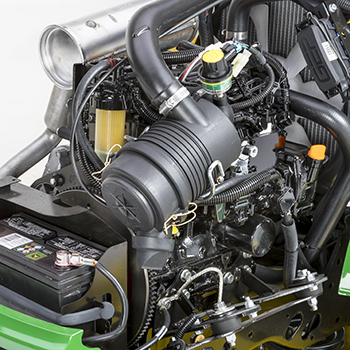 Diesel engine
Diesel engine
A liquid-cooled, 3-cylinder diesel engine provides exceptional power, performance, fuel economy, and durability to handle commercial-use applications:
- Large displacement provides exceptional torque
- Cast-iron block improves noise absorption
- Quality features include cast-iron cylinder liners, overhead valves, full-pressure lubrication, and replaceable oil filter
- Solenoid-shift starter ensures easy starts, even in cold weather
- High-energy glow plugs ensure quick starts in cold weather; an automatic sensing system tells the operator when the engine is ready to start
- Mechanical fuel bleed eliminates the need for tools and fuel leaking onto the ground when bleeding the fuel system:
- Simply pump the fuel pump that is located on the side of the engine
- Electric fuel shutoff eliminates the need for a separate kill switch
- Indirect injection with pre-combustion chambers provide smooth, quiet operation
- Engine-mounted 40-amp alternator supplies regulated charge to the battery for fast recharge:
- Also provides plenty of power for 12-volt-powered attachments and accessories
- Low exhaust emissions are certified to meet U.S. Environmental Protection Agency (EPA) and state of California standards for cleaner air:
- Overhead valve design for efficient airflow
- Swirl chamber combustion design for efficient combustion
- Liquid cooled for more consistent operating temperatures
- Closed crankcase ventilation recirculates and burns crankcase hydrocarbons
Horsepower (hp) |
Maximum torque |
Cooling |
Displacement |
24 hp (17.9 kW) |
--- |
Liquid |
60.6 cu in. (993 cc) |
Air-intake system
 Air intake screens on hood and pedestal
Air intake screens on hood and pedestal
 Radiator screen pulled out for cleaning
Radiator screen pulled out for cleaning
Engine intake air is drawn in through screened panels at the base of the pedestal and on the right and left sides of the tractor:
- Cleanest and coolest area of the tractor
- Pre-cleans the air to keep large chaff and debris from entering the radiator or air cleaner
- Easy to clean and service so engine operates at optimum temperature
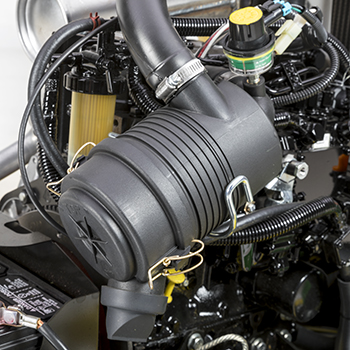 Diesel engine air cleaner
Diesel engine air cleaner
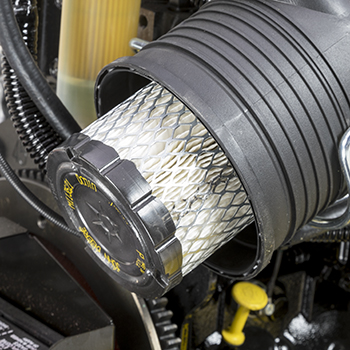 Replaceable air filter
Replaceable air filter
The diesel engine uses a heavy-duty cyclonic canister-type replaceable air filter:
- Completely sealed for effective cleaning
- Cyclone action that is designed to eject 90 percent to 95 percent of the dirt before it reaches the paper element
- Secondary safety element that provides additional filtering
- Total effective filter area of 512 sq in. (3303 sq cm)
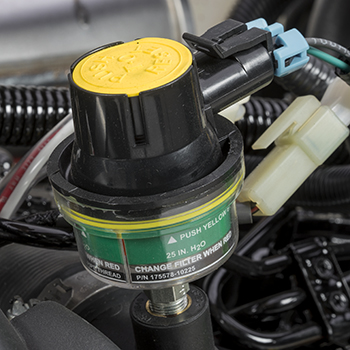 Air filter restriction indicator
Air filter restriction indicator
An air filter restriction indicator is standard equipment:
- Indicator light on the dash alerts the operator when the air filter is dirty and needs to be replaced
- With a visual check, air filter daily service is simplified
- Indicator extends the engine life by eliminating inadvertent dirt entry into the engine from over-servicing of the air filter
Fuel tank has a large 5.2-U.S. gal. (19.7-L) capacity
 Fuel cap and tank (shown on X758 Diesel Tractor)
Fuel cap and tank (shown on X758 Diesel Tractor)
 Fuel filter, separator, and shutoff
Fuel filter, separator, and shutoff
A large, 5.2-U.S. gal. (19.7-L) capacity fuel tank holds enough fuel for extended operation between refills:
- Fuel-fill location is on the left fender for easy access, increased safety, fewer spills, and convenience during filling.
- A fuel filter/separator with replaceable element includes a shutoff valve and is conveniently located on the front of the engine.
Battery and alternator are large capacity
 Battery located at front of tractor frame
Battery located at front of tractor frame
A high-capacity, regulated alternator charging system provides plenty of power to quickly recharge the battery and run electrical equipment, such as lights or a sprayer:
- 40-amp alternator is provided as standard equipment on diesel engines.
A large-capacity, 500 cold-cranking amp battery provides plenty of cranking power for quick, sure starts in cold weather:
- Mounted at the front of the tractor frame for easy accessibility
54-in. (137-cm) and 60-in. (152-cm) Edge™ High-Capacity (HC) Mower Decks are heavy duty
 X739 Tractor mowing with 54-in. (137-cm) HC Mower Deck
X739 Tractor mowing with 54-in. (137-cm) HC Mower Deck
 Side view of mower deck
Side view of mower deck
A deep-deck design of 5.5 in. (14 cm) delivers excellent airflow so material can be processed quickly and efficiently. The deck is stamped from 9-gauge, 0.15-in. (3.8-mm) steel and has welded-on reinforcement at the bottom edge for extra strength and durability.
 60-in. (152-cm) HC Mower Deck top view
60-in. (152-cm) HC Mower Deck top view
 54-in. (137-cm) HC Mower Deck bottom view
54-in. (137-cm) HC Mower Deck bottom view
High-capacity mower decks are formed in a hydraulic press to minimize the number of welds and provide a smooth underside for reduced material buildup:
- Wider and higher discharge opening provides an even clipping dispersal for an excellent finished appearance in all conditions.
- Durable plastic deflector spreads grass clippings evenly across the lawn, is hinged, and can be raised to minimize the storage space required.
- 1-in. (2.5-cm) cold-forged spindles are heat-treated for strength and supported by ball bearings.
- Front edge is raised above the blade plane to allow even cutting of tall grass.
- Blade overlap is greater than many conventional decks for a clean cut.
- Mower can side-discharge, mulch (optional), or use a Power Flow™ collection system (optional).
 MulchControl with baffle closed
MulchControl with baffle closed
 MulchControl with baffle open
MulchControl with baffle open
The MulchControl attachment makes mulching more practical for many mowing situations because it not only does an excellent job of mulching but it also allows the mower to be easily converted for times when it is more desirable to side discharge or collect the lawn material. Advantages of mulching grass clippings include:
- A beautiful looking lawn
- Grass clippings not blown onto the operator, driveways, or flower beds
- Less fertilizer use
- Elimination of the effort needed to dispose of clippings
MulchControl is an innovative, simple design that is easy to use and maintain:
- The MulchControl attachment includes baffles to control the flow of material under the deck.
- The left mower blade area is completely enclosed and optimized for mulching, thus will mulch even when the mower is in the side-discharge mode.
- Baffles around the center and right blades are optimized for mulching when the discharge baffle is closed.
MulchControl operation
 MulchControl handle (standard with MulchControl)
MulchControl handle (standard with MulchControl)
 Hydraulic MulchControl actuator option
Hydraulic MulchControl actuator option
The optional MulchControl attachment comes with a handle on top of the mower deck that is used to open and close the discharge baffle:
- The operator is required to get off of the machine in order to engage or disengage mulch mode.
An optional hydraulic MulchControl actuator attachment is available to replace the standard control lever and allow the operator to control MulchControl from the seat using the tractor’s hydraulic control lever.
NOTE: To have hydraulic control of the MulchControl baffle, both MulchControl and hydraulic MulchControl actuator attachments must be ordered. The hydraulic MulchControl actuator is an extra-cost option for the MulchControl attachment.
Changing from mulching to side discharge or vice versa with the hand lever or hydraulic MulchControl actuator option takes only a few seconds.
MulchControl is well-suited to the following mowing situations:
- Usually mulch, but side discharge when grass gets too long
- Usually side discharge, but would like to be able to close the chute to control clippings
- Always mulch a main lawn, but often side discharge secondary lawns
- Bag clippings, but want to go farther before emptying bags
MulchControl puts the operator in control of the clippings. Now the operator can have all the benefits of mulching with the ability to easily change to side-discharge or bagging when needed.
MulchControl limitations
While in the side-discharge mode, MulchControl will still mulch about one-third of the material. Therefore, the side-discharge mode is essentially a partial-mulch mode. This can be an advantage when side discharging or bagging, as it helps to reduce the amount of material being discharged. Other times this could work as a disadvantage:
- When cutting strong southern grasses, such as Zoysia and Bermuda
- When cutting in wet, high-growth conditions, such as those found in the Pacific Northwest United States
- When optimum bagging and lawn clean-up is desired
MulchControl compatibility
MulchControl is a field-installed attachment. Mulching blades are included:
- MulchControl is for 2015 and newer X700 Signature Series Tractor and:
- 9074M 54-in. (137-cm) HC Mower Deck (serial number 030,001-070,000)
- 9078M 54-in. (137-cm) HC Mower Deck (serial number 070,001-)
- 9075M 60-in. (152-cm) HC Mower Deck (serial number 030,001-070,000)
- 9079M 60-in. (152-cm) HC Mower Deck (serial number 070,001-)
- Optional hydraulic MulchControl actuator (BUC10536) is available for model year 2019 and newer mower decks (9078M and 9079M) only. In addition, mower must be equipped with the basic MulchControl attachment.
NOTE: The hydraulic MulchControl actuator is not available for the 48-in. (122-cm) Accel Deep™ Mower Deck.
Order:
BM26300 MulchControl attachment (54 HC)
BM25258 MulchControl attachment (60 HC)
BUC10536 Hydraulic MulchControl actuator
 Tire-grab feature and shark tooth shaped grips
Tire-grab feature and shark tooth shaped grips
 Drive-over ramp removed for spindle access
Drive-over ramp removed for spindle access
Ramps are provided to permit driving over the mower deck for installing and removing it from the tractor:
- Constructed of 30 percent glass-filled polypropylene for strength to carry the weight of the tractor
- Polypropylene material will not rust or corrode for lasting good appearance
- Shark tooth shaped grips designed into the ramp inclines for added wheel traction when driving onto the mower deck
- Tire grab at the rear of the ramp gives extra wheel traction
- Ramps removed and replaced without tools to permit convenient servicing of the mower spindles
 Mower wash port
Mower wash port
 Mower wash port with hose connector
Mower wash port with hose connector
A wash port is provided to make cleaning the underside of the mower deck easy:
- Hose connector is included with the mower deck.
Optional high-performance mulching attachment
 Mulching attachment components (48 HC shown)
Mulching attachment components (48 HC shown)
The high-performance mulching attachment provides excellent mulching performance:
- This is a high-performance mulching attachment that includes formed steel baffles to control the material and special mulching blades for superior performance.
- The special mulching blades that are included can also be used for side discharging and collecting, though overall performance may be slightly less than with the standard blades.
- Order: BM23977, 54 HC mulching attachment or BM23978 60 HC mulching attachment
Optional MulchControl™ attachment
Mower deck attachability
 X758 Tractor driving onto high-capacity mower deck
X758 Tractor driving onto high-capacity mower deck
High-capacity mower decks have ramps positioned on top of the deck for easy installation:
- On a four-wheel drive (4WD) tractor, the operator can simply drive onto and over the deck.
- On a two-wheel drive (2WD) tractor, the operator must back onto and over the deck.
To remove the mower deck:
- Disconnect the drive shaft.
- Unlock the draft arm locks.
- Back or drive the tractor onto and off the mower deck.
- On a 4WD tractor, the operator can simply back onto and off the deck.
- On a 2WD tractor, the operator can simply drive forward onto and off the deck.
Optional AutoConnect™ drive (BM25677)
 X758 Tractor driving onto high-capacity mower deck
X758 Tractor driving onto high-capacity mower deck
 AutoConnect option installed on X758 Tractor
AutoConnect option installed on X758 Tractor
The AutoConnect driveshaft is an optional kit that will automatically connect or remove the drive from the mower deck to the tractor's mid power take-off (PTO) shaft.
The AutoConnect drive does not need to be removed from the tractor when using front-powered equipment.
Drive-over mower quick reference (major steps)
John Deere has designed a system that makes it easy to remove and reinstall the mower deck. A few steps need to be followed carefully to ensure success.
The list below includes the major steps. Refer to the operator’s manual for a more detailed procedure. The tractor most likely has the mower already installed, so these steps begin with the removal procedure.
DRIVEJD - Always Dependable Product
Mower removal steps
Drive tractor to level area.
Ready mower deck.
- Adjust wheels and lower mower deck
- Draft arms removed (front) and released (rear)
- Power take-off (PTO): disconnect if manual PTO-connect system, then back up to clear rear draft arms (If equipped with AutoConnect™, backing up also disconnects the PTO)
- Raise rear draft arms
Increase engine speed, engage traction assist, and drive over.
Mower installation steps
Verify tractor and mower are ready.
- Alignment of tractor and mower deck
- Draft arms up
- PTO in correct position (If manual PTO connect, place shaft in mower hanger)
Engage traction assist, increase engine speed, and drive or back over.
Join mower to tractor.
- Alignment and attachment verified and PTO connected
- Draft arms hookup, front
- Position mower wheels
Done! Set mower deck height and mow.
Four-year or 700-hour bumper-to-bumper warranty is standard
An exclusive 4-year or 700-hour (whichever comes first), single-source, bumper-to-bumper warranty* is standard for all John Deere X700 Series Tractors.
- The warranty is hassle free, with one company handling all of the paperwork.
- Premium features of X700 Series Tractors allow for this longer warranty period, with more coverage than comparable tractors.
*Term limited to years or hours used, whichever comes first, and varies by model. See the LIMITED WARRANTY FOR NEW JOHN DEERE TURF AND UTILITY EQUIPMENT at JohnDeere.com or JohnDeere.ca/TUWarranty for details.
Four-wheel power steering for superior maneuverability and trimming
 X734 Tractor trimming around tree
X734 Tractor trimming around tree
 X739 Tractor trimming around a tree
X739 Tractor trimming around a tree
Power steering is standard equipment on all X700 Series Tractors. It provides effortless, automotive-like control:
- Reduced operator fatigue
- Better maneuverability
- Increased productivity
Four-wheel power steering on the X734, X739, and X754 Tractors provides very significant maneuverability and trimming advantages over two-wheel-steering equipped tractors:
1. The uncut circle diameter is greatly reduced, eliminating or greatly reducing the need to back up when trimming around trees, shrubs, etc.
- Cutting inside turns created by landscaping, flower beds, etc. can also be done much more efficiently with a four-wheel-steer equipped tractor.
2. Interference from the mower and tractor wheels is eliminated because they are several inches away from the object being trimmed around.
- When cutting rectangle-shaped areas, square corners can be cut more effectively and efficiently.
3. The outside turning circle is reduced, decreasing the time spent turning and increasing mowing efficiency.
The X739 Tractor has both full-time four-wheel drive (4WD) and four-wheel steering, which gives it the optimum in both traction and maneuverability.
|
Two-wheel steer (X730, X750) |
Four-wheel steer (X734, X754) |
Full-time 4WD (X738, X758) |
Full-time 4WD with four-wheel steer (X739) |
Turning radius |
25 in. (63.5 cm) |
21 in. (53.3 cm) |
25 in. (63.5 cm) |
21 in. (53.3 cm) |
Uncut circle radius (60- in. (152-cm) mower deck) |
28 in. (71.1 cm) |
6 in. (15.2 cm) |
28 in. (71.1 cm) |
6 in. (15.2 cm) |
Turns lock-to-lock left |
2.4 |
2.5 |
2.3 |
2.2 |
Turns lock-to-lock right |
2.4 |
2.5 |
3.1 |
2.8 |
Operator station is comfortable and convenient
 X730 Tractor mowing
X730 Tractor mowing
 Tilt steering wheel
Tilt steering wheel
The tilt steering wheel can be adjusted for optimum operator comfort:
- Six positions can be selected with the push of a lever for the most comfortable setting.
- The full-up position makes getting on and off the tractor easy.
- The steering wheel is designed for comfortable, no-slip operation.
Two-piece tilt-back seat
 Seat has convenient tilt-back feature
Seat has convenient tilt-back feature
 Seat tilted forward
Seat tilted forward
Two-piece, 21-in. (53-cm) high-back seat, with John Deere branded embroidery, has a thick seat cushion for lasting comfort, even after a full day of use. The back can be angled to maximize operator comfort by using a convenient lever on the side of the seat.
A four-bar adjustable seat suspension and 7-in. (18-cm) slide-rail fore-aft adjustment are provided to optimize operator comfort.
Optional armrest kit
 Adjustable armrest option
Adjustable armrest option
 Left armrest in raised position
Left armrest in raised position
Optional armrests increase operator support and comfort, thus reducing fatigue and improving productivity, especially when mowing for extended periods of time. Armrests are adjustable to suit the operator. The embroidered logo on the seat back makes this upscale seat look as good as it feels.
Optional air-ride suspension seat
 Optional air-ride suspension seat
Optional air-ride suspension seat
 Seat pressure switch and fore-aft adjustment lever
Seat pressure switch and fore-aft adjustment lever
The optional air-ride seat minimizes vibration the operator feels while using the tractor and provides a very smooth ride. This seat has a full pneumatic suspension that is easy for operators to adjust to suit their individual needs. Wide, shaped ergonomic cushions are comfortable and reduce back strain.
Features include:
- Simple switch on the front of the seat makes adjustment easy
- Back-angle adjustment
- Three-position lumbar adjustment
- Armrest height adjustment
- 7-in. (18-cm) fore-aft adjustment
Key benefits of the seat:
- Provides maximum ride comfort and quality, thus minimizing operator fatigue
- Dampens lower frequency vibration better than mechanical suspensions
NOTE: The air-ride seat is compatible with all X700 Signature Series Tractors, model year 2013 and later (serial number 010,001-). Plug and play wiring harness for use with the air-ride suspension seat has been added to model year 2019 tractors (serial number 70,001-) to reduce seat-installation time. Model year 2013-2018 (serial number 010,001-070,000) requires AM146765 wiring harness. See CCMS solution 115258 for more information.
Foot pads
 Foot pads
Foot pads
Foot pads help isolate the operator's feet from vibration:
- Provide a non-slip surface for safer mounting or dismounting the tractor
- Attractive styling
Handgrips, toolbox, cup holder, and 12-V outlet
 Toolbox and handgrip
Toolbox and handgrip
 Toolbox with cover open and cup holder
Toolbox with cover open and cup holder
The fender handles provide a convenient handhold to use when getting on and off the tractor and when operating on slopes:
- Plastic material is durable and will not rust.
- The cup holder is designed to hold a variety of drink container sizes.
- Toolbox provides a safe and convenient location to store tools and supplies.
- Exact Adjust mower leveling tool and gauge storage features are provided in the tool box.
12-V outlet
 12-V outlet
12-V outlet
 12-V outlet with cover open
12-V outlet with cover open
12-V outlet located for the convenience of connecting a variety of electrical and electronic equipment:
- Outlet switch is located on the dash for starting and stopping an electric spreader or sprayer.
Headlights and taillights provide good visibility
 Two high-quality headlights
Two high-quality headlights
Large, automotive-type headlights and taillights provide unsurpassed nighttime illumination:
- Standard 37-W halogen headlights provide excellent nighttime visibility.
- Large automotive-type taillights enhance the tractor's appearance and safety.
- Headlights, taillights, and rear work lights are easily operated with a single dash-mounted switch.
 Taillights, work lights, and backup lights
Taillights, work lights, and backup lights
Rear lights provide visibility for the tractor operator and others:
- Standard backup lights can be turned on full time to double as rear work lights.
- Backup lights come on automatically when the operator depresses the reverse pedal.
Snow removal and yard care equipment
An advantage of X700 Series Garden Tractors is their ability to use attachments for snow removal and a variety of other yard-care tasks.
The front quick-hitch mounting system allows for a tool-free change between the front blade, rotary broom, and snow blower. Additional attachments available for use with the equipment listed below include:
- Quik-Tatch tractor frame weights to add ballast for traction and stability
NOTE: Ballast is required for some applications. - Tire chains or TerraGrip traction belts for extra traction when using snow-removal equipment
- Weather protection (shown below) for operator protection and comfort
47-in. (119-cm) and 54-in. (137-cm) Quick-Hitch Snow Blowers
 47-in. (119-cm) Snow Blower, optional front light kit shown
47-in. (119-cm) Snow Blower, optional front light kit shown
 54-in. (137-cm) Snow Blower, optional front light kit shown
54-in. (137-cm) Snow Blower, optional front light kit shown
NOTE: One drift knife is standard equipment; the second (shown in images above) is optional.
The 47-in. (119-cm) and 54-in. (137-cm) Snow Blowers have the capacity to handle big snow-removal jobs.
The front quick-hitch mounting system allows for a tool-free change between the front blade, rotary broom, and snow blower.
42-in. (107-cm) and 47-in. (122-cm) Rotary Tillers
 42-in. (107-cm) Hydraulic Rotary Tiller
42-in. (107-cm) Hydraulic Rotary Tiller
 647 Rotary Tiller
647 Rotary Tiller
The 42-in. (107-cm) Hydraulic Tiller is a real time-saver in preparing seedbeds, controlling weeds, and other tillage jobs. Potential customers include homeowners, hospitals, schools, nurseries, estates, lawn and garden centers, etc. The hydraulic tiller is quieter, more powerful, and tills up to 6 in. (15 cm) of depth. This provides flexibility for jobs like sod breaking to conventional garden tilling.
A unique feature of the 42-in. (107-cm) Hydraulic Tiller is its ability to operate with either forward or reverse tine rotation. This provides flexibility for jobs from sod breaking to conventional garden tilling.
- In forward tine rotation, the hydraulic motor is on the right side and the tines turn in the same direction as the tractor tires when the tractor travels forward for tilling most soil conditions, including soil already tilled and soft soil.
- In reverse tine rotation, the hydraulic motor is on the left side and the tines turn in the opposite direction as the tractor tires when the tractor travels forward for tilling hard soils or sod.
The 647 Rotary Tiller is 47-in. (122-cm) wide and ideal for preparing seedbeds, controlling weeds, and other tillage jobs for homeowners, golf courses, hospitals, schools, and estates. It requires a tractor equipped with a Category 1, 3-point hitch and 540-rpm rear power take-off (PTO).
52-in. (132-cm) and 60-in. (152-cm) Rotary Brooms
 52-in. (132-cm) Rotary Broom (shown with optional front light kit)
52-in. (132-cm) Rotary Broom (shown with optional front light kit)
 60-in. (152-cm) Heavy-Duty Rotary Broom
60-in. (152-cm) Heavy-Duty Rotary Broom
The 52-in. (132-cm) and 60-in. (152-cm) Rotary Brooms increase tractor versatility by allowing use for a variety of sweeping jobs. The broom effectively meets the needs of commercial, farm, home, and estate operators with four-season versatility:
Spring
Rotary brooms can be used to dethatch lawns and clean off tennis courts and other areas quickly and effectively.
Summer
Rotary brooms effectively perform a wide variety of sweeping jobs, including cleaning sidewalks, parking lots, driveways, construction job sites, and barns. They can also be used for backfilling trenches.
Fall
Rotary brooms can be used to sweep leaves and windrow pine needles. They sweep artificial turf and clean up spectator areas after sporting events.
Winter
Rotary brooms effectively move up to 2 in. (5 cm) of snow, which may eliminate the need for a snow thrower, depending on the geographic area.
54-in. (137-cm) and 60-in. (152-cm) Quick-Hitch Front Blades
 54-in. (137-cm) Quick-Hitch Front Blade
54-in. (137-cm) Quick-Hitch Front Blade
 60-in. (152-cm) Quick-Hitch Front Blade
60-in. (152-cm) Quick-Hitch Front Blade
The 54-in. (137-cm) and 60-in. (152-cm) Front Blades are excellent for moving snow, gravel, dirt, sand, or other loose material. They can be hydraulically angled up to 27 degrees right or left or used in the straight-ahead position.
Weather enclosure and hard-side cab
 Weather enclosure
Weather enclosure
 Hard-side cab
Hard-side cab
The roomy steel-frame weather enclosure shields the operator against snow, rain, sun, and wind.
This hard-side cab is rollover protection structure (ROPS) certified for extra protection:
- An electric front windshield wiper is included.
- Optional attachments for the hard-side cab include a heater, heater disconnect kit, inside and outside mirrors, rear window wiper, strobe light, work lights, switch panel fuse block kit, and optional tractor alternators to provide extra capacity to operate the cab accessories.
Instruments and controls are easy to find and use
 Instrumentation and controls (switch turned off)
Instrumentation and controls (switch turned off)
 Gauges and indicator lights (switch turned on to illustrate functions)
Gauges and indicator lights (switch turned on to illustrate functions)
The contoured dash has clean, attractive styling and ergonomic controls for easy use:
- Controls are color coded for easy identification by the operator.
- Controls are logically placed and easy to reach.
- The power take-off (PTO) switch allows the operator to get fingers underneath it, like a T-handle, to pull up for easy activation.
- The reverse implement option (RIO) switch is an easy-to-see and easy-to-use yellow button.
- Cruise control activation is handled by an automotive-style button.
- Functional design of the throttle control provides good appearance and a comfortable feel.
 Display panel illustration with descriptions
Display panel illustration with descriptions
The instrument display has the look and feel of a modern automobile. A power-up sequence cycles lights and gauges to indicate they are working:
- Display features dark-cockpit design to minimize operator distractions.
- Display is back lit for night visibility.
- Night visibility is especially useful with snow blower use.
- Hour meter makes it easy to tell when oil changes and other maintenance should be performed.
- Electronic fuel gauge provides real-time fuel level information.
- A tachometer graphically displays engine speed.
- Target-zone graphics inform the operator of the engine speed range to use for best cut quality.
- An indicator tells the operator when the PTO is operating.
- Bright caution and stop lights capture the operator's attention when important information is on the instrument cluster.
- Damage can be prevented and repair costs reduced by addressing problems early.
- Operators are advised of what the problem is if they attempt to operate the mower with unsatisfied PTO, seat, or park brake interlocks.
- The indicators are also useful to identify the reasons the PTO or engine may have shut off when an interlock is unsatisfied.
- Operators are advised if battery voltage is low, normal, or excessive.
- The service indicator light illuminates to indicate a diagnostic error code is stored.
- On-board diagnostics provides trouble codes for use by trained technicians.
- For example, a technician will be able to test switch functionality and circuit continuity without tools.
- On-board diagnostics provides trouble codes for use by trained technicians.
Exact Adjust
 Exact Adjust tool and mower leveling gauge
Exact Adjust tool and mower leveling gauge
Exact Adjust tool and mower deck leveling gauge are stored in the toolbox to provide a convenient means of checking and adjusting the deck level:
- Used in conjunction with Exact Adjust ports for easy and accurate leveling of the mower deck for optimum mowing performance
Twin Touch™ foot control is easy to use and has cruise control
 Twin Touch foot control
Twin Touch foot control
 Cruise control
Cruise control
Twin Touch foot pedals control the speed and direction of travel:
- Automotive-type accelerator control for easy operation
- Twin Touch design that allows operator to change direction without lifting foot off platform
- Large pedal surface for increased operator comfort
When the master brake pedal is depressed, the PTO and cruise control disengage.
Cruise control is standard equipment:
- To engage, push in on the cruise lever and hold until the foot is removed from the forward pedal.
- For emergency stop, the cruise control can be released by pushing on the master brake pedal or pushing down on the forward pedal.
Differential lock
 Differential lock control
Differential lock control
A foot-operated differential lock supplies positive power to both rear drive wheels for increased traction:
- Differential lock button is conveniently located on the left footrest for easy engagement.
Parking brake control
 Controls shaped and located for easy use
Controls shaped and located for easy use
 Park brake control and brake pedal
Park brake control and brake pedal
The parking brake control is conveniently located below the key switch on the steering pedestal:
- Holds the brake pedal securely in the locked position
Depressing the brake pedal disengages the PTO and cruise control:
- Allows the engine to be started
- Applies wet-disk brakes (internal in transmission) for use as a parking brake
Mower deck height-of-cut control
 Mower deck height-of-cut control
Mower deck height-of-cut control
 Exact Adjust ports
Exact Adjust ports
The depth stop allows setting the mower height from the operator's seat:
- Locks the mower in fully raised position so 3-point hitch equipment can be raised or lowered independently of the mower
- Returns mower deck to the same preset height each time it is lowered
- Provides a mower cut-height range from 1 in. to 5.25 in. (2.5 cm to 13.3 cm)
- Informs the operator of the approximate mower cut-height through an indicator
Exact Adjust ports on either side of the fender deck allow access to the rear mower deck height adjusting links:
- Allow mower deck to be easily leveled side-to-side
- Leveling can be done from above the fender deck by using the Exact Adjust tool
Hydraulic power steering gives effortless control
 X734 Tractor trimming around a tree
X734 Tractor trimming around a tree
 Power steering control valve
Power steering control valve
Power steering is standard equipment. It provides effortless, automotive-like control:
- Reduced operator fatigue
- Better maneuverability
- Increased productivity
|
Two-wheel steer (X730, X750) |
Four-wheel steer (X734, X754) |
Full-time four- wheel drive (X738, X758) |
Full-time four-wheel drive with four- wheel steer (X739) |
Turning radius |
25 in. (63.5 cm) |
21 in. (53.3 cm) |
25 in. (63.5 cm) |
21 in. (53.3 cm) |
Uncut circle radius (60- in. (152-cm) mower deck) |
28 in. (71.1 cm) |
6 in. (15.2 cm) |
28 in. (71.1 cm) |
6 in. (15.2 cm) |
Turns lock-to-lock left |
2.4 |
2.5 |
2.3 |
2.2 |
Turns lock-to-lock right |
2.4 |
2.5 |
3.1 |
2.8 |
 Deck-leveling gauge placed under deck
Deck-leveling gauge placed under deck
 Using included ball-hex tool to level mower deck
Using included ball-hex tool to level mower deck
Consult the operator's manual for the correct adjusting procedure. Basic adjusting steps to properly level the mower deck include:
- Park the tractor on a level surface.
- Inflate tires to the correct pressure.
- Consult the label for the cutting-height knob that is located on the console of the machine. This label shows deck-leveling position and location of deck-leveling adjustment points.
- Set mower cutting-height knob to the correct deck-leveling position.
- Adjust mower wheels as necessary so they do not contact the ground surface.
- Remove the onboard deck-leveling gauge and Exact Adjust tool that are located in the tractor toolbox.
- Using the Exact Adjust ports and tool, adjust mower deck side-to-side level so the deck-leveling gauge just slips under the left and right lower deck rim. The location of adjustment points will vary slightly between decks.
- Left- and right-rear adjustment points are under the deck rim near the rear mower wheels.
- Adjust mower deck front-to-back level, if necessary.
- Loosen rear nuts equally on each side of front lift rod.
- Turn front nut equally on each side clockwise to raise front of mower or counterclockwise to lower it until gauge just slips under the front adjustment point.
- Front adjustment point varies by mower deck
- Tighten rear nuts after adjustment is complete.
- Return the gauge and tool to their storage position in the toolbox.
NOTE: The adjusting tool supplied with the tractor is an 8-mm ball-hex key. The rounded end allows for some misalignment with the bolt as the deck is adjusted.
Two-function hydraulics give effortless control of equipment
 Dual hydraulic control levers
Dual hydraulic control levers
A two-function hydraulic control system is standard equipment.
The hydraulic system allows effortless equipment control:
- Raising and lowering
- Angling and spout rotation
- Control levers
- Levers are positioned on the steering pedestal for quick, easy, and precise fingertip control of equipment.
- Lower lever has a float position, allowing front-mounted equipment such as a blade, snow blower, or rotary broom to follow the contour of the ground.
 Hydraulic outlets
Hydraulic outlets
Four hydraulic couplers with color-coded covers are available for quick, easy connections.
Modern styling has a functional design
 Functional and attractive design includes alloy wheels
Functional and attractive design includes alloy wheels
 Styled hood and seat
Styled hood and seat
John Deere Signature Series are the very best mowing tractors available and can also handle a wide range of other yard care chores, such as snow removal, lawn cleanup, and landscaping work. These heavy-duty tractors include models with two-wheel drive (2WD) and four-wheel drive (4WD), two- and four-wheel steering, and even a model with full-time 4WD and four-wheel steering.
Standard equipment styled alloy wheels and John Deere brand embroidery:
- Standard equipment styled alloy wheels give X700 Series Tractors a fresh, upscale appearance that goes well with their high-quality standards and superior performance.
- John Deere brand embroidery has been added to the standard equipment 21-in. (53-cm) two-piece adjustable seat to make it look as good as it feels.
The open platform is roomy and uncluttered:
- Makes getting on and off the tractor easy
- Provides ample legroom with built-in heel pockets for comfortable operation
The single-piece hood completely encloses the engine:
- Improves appearance
- Provides quieter operation
- Easy to remove for service accessibility
- Painted hood
- More scratch and scuff resistant than molded-in color
- Deep scratches repairable with paint
Important advantages for superior mowing performance and equipment versatility
 X730 Tractor mowing
X730 Tractor mowing
 X754 Tractor mowing
X754 Tractor mowing
Available mower decks include a 48-in. (122-cm) Accel Deep™ Mower Deck or 54-in. (137-cm) or 60-in. (152-cm) Edge™ High-Capacity Mower Deck. All mowers have premium design features to give a clean, level cut and excellent performance, whether side discharging, mulching, or collecting lawn material.
X700 Signature Series Tractors offer these important performance advantages:
- Heavy-duty robotically welded frame for the strength to operate a wide variety of equipment
- Plenty of engine horsepower and torque to operate larger equipment
- Electronic fuel injection (X730, X734, X738, X739)
- Fast and sure starts
- Better fuel economy than carbureted engines
- Reduced emissions
- Diesel models (X750, X754, X758)
- Increased durability
- Improved fuel economy
- U.S. Environmental Protection Agency (EPA) Final Tier 4 compliant
- Easy-to-operate Twin Touch™ foot-controlled hydrostatic transmission
- Power steering for quick, precise control
- Four-wheel drive for optimum traction in any use and ground condition (X738 and X758)
- Four-wheel steering for unsurpassed trimming ability (X734 and X754)
- Full-time four-wheel drive and four-wheel steering for unsurpassed traction, maneuverability, and trimming ability (X739)
- Differential lock for increased traction control
- Hydraulic power take-off (PTO) clutch with soft, modulated engagement
- Shaft-driven equipment versus a belt drive
- Shaft-driven transmission versus a belt drive
- Automotive-type dash instrument cluster with gauges and indicator lights
- Two-spool hydraulic control valve with outlets
- From-the-seat adjustable mower depth stop with gauge
- Exact Adjust mower-leveling feature with onboard gauge and adjusting tool
- Automotive-type headlights and taillights
- Optional 540-rpm rear PTO
- Optional limited Category 1 3-point hitch for rear-mounted equipment
Frame is full-length welded steel for strength
 Full-length welded steel frame
Full-length welded steel frame
The full-length, welded C-channel steel frame provides plenty of strength to handle heavy equipment:
- Frame side rails are formed from 7-gauge, 0.18-in. (4.6-mm) steel for extra strength.
- The front bumper/weight bracket is formed from heavy, 0.375-in. (9.5-mm) steel.
The frame is robotically metal inert gas (MIG) welded:
- Consistent welds for maximum strength
- No bolts to come loose
A front Quik-Tatch weight bracket is designed into the frame:
- Provides a convenient way to add up to 168 lb (76 kg) of weight to the front of the tractor using four suitcase weights
- Extends ahead of the hood to act as a bumper
 Front receiver hitch
Front receiver hitch
 Optional drawbar/ball mount and hitch ball shown
Optional drawbar/ball mount and hitch ball shown
A front receiver hitch is designed into the frame:
- Optional drawbar/ball mount and hitch balls are available.
- Excellent for positioning trailers, boats, etc., in tight quarters.
An optional rear receiver hitch is available.
Front axle and wheel spindles are heavy duty
 Heavy-duty cast-iron front axle (2WD shown)
Heavy-duty cast-iron front axle (2WD shown)
 Heavy-duty cast front axle (4WD shown)
Heavy-duty cast front axle (4WD shown)
The front axles are made of strong, shock-resistant cast iron:
- Will not bend or deform, as is possible with steel-fabricated axles
- Replaceable bushings are used at the center axle pivot and spindles
- Provide excellent wear resistance
- Easy service and maintenance with grease fittings
 1-in. (2.5-cm) diameter front-wheel spindle (2WD)
1-in. (2.5-cm) diameter front-wheel spindle (2WD)
 Cast-iron front spindle/wheel motor (4WD)
Cast-iron front spindle/wheel motor (4WD)
The 2WD tractors use large, 1-in. (2.5-cm) diameter wheel spindles for durability:
- Have the strength to handle heavy front implements
- Provide long life at bearing surfaces
- Use sealed precision bearings in the front wheels for long life
The 4WD tractors use heavy-duty cast and machined front spindle and wheel motor assemblies for durability and long life.
Hydrostatic drive with Twin Touch™ control is easy to operate
 Twin Touch foot control
Twin Touch foot control
 Cruise control
Cruise control
Twin Touch foot pedals control the speed and direction of travel:
- Automotive-type accelerator control for easy operation
- Twin Touch design that allows operator to change direction without lifting foot off platform
- Large pedal surface for increased operator comfort
When the master brake pedal is depressed, the power take-off (PTO) and cruise control disengage.
Cruise control is standard equipment:
- To engage, push in on the cruise lever and hold until the foot is removed from the forward pedal.
- For emergency stop, the cruise control can be released by pushing on the master brake pedal or pushing down on the forward pedal.
Heavy-duty two-wheel steer or four-wheel steer transaxle
 X758 two-wheel steer transaxle shown
X758 two-wheel steer transaxle shown
A rugged, heavy-duty commercial hydrostatic transaxle handles a wide variety of ground-engaging applications and commercial mowing usage. A hitch for tow-behind equipment is included. The tractor frame extends behind the transaxle to provide mounting points for the category 1 3-point hitch and Click N Go™ mounting brackets.
Many quality features are provided:
- Universal joint splined drive shaft between the engine and transmission is durable and gives efficient power transfer (no belts, no slippage, no power loss).
- Shaft drive output through continuous live transmission PTO has no belts to slip or wear out.
- Internal hydraulic PTO with a multi-disk clutch pack:
- Soft, smooth clutch engagement
- Longer disk life with continuous oil bath
- No service required, as disks are self-adjusting
- Internal, wet-disk brakes:
- Isolated from dirt, rust, ice, or other contaminants for effective brake operation
- Constantly cooled by transmission fluid to minimize wear and eliminate the loss of brakes from overheating
- Quiet design virtually eliminates hydrostatic whine.
- Large, efficient 6-cc charge pump produces excellent flow and pressure to allow operating a variety of hydraulic-powered equipment.
- Externally mounted, oil-filled shock absorber in the control system ensure smooth starts and stops.
- Exceptional strength and durability:
- Automotive-type forged flanged axles
- Heavy ribbed aluminum die-cast axle housings
- Uses an axial piston-type pump and motor versus less-efficient ball-type rotating groups
 Two-wheel steer hydrostatic transaxle
Two-wheel steer hydrostatic transaxle
 Four-wheel steer hydrostatic transaxle
Four-wheel steer hydrostatic transaxle
Two-wheel drive (2WD) and four-wheel drive (4WD) tractors use similar transaxles, however, four-wheel steer tractors have additional features that allow the rear wheels to turn.
 Differential lock control
Differential lock control
Infinite control of ground speed and smooth change of direction provide efficiency and operator convenience. The differential lock provides positive power to both drive wheels for increased traction. It can be engaged by the operator as needed.
| Forward | 0 to 8.5 mph (0 to 13.7 km/h) |
| Reverse | 0 to 6 mph (0 to 9.7 km/h) |
Transmission oil cooler
A transmission oil cooler is standard equipment:
- Helps keep oil temperatures cooler during high draft-load operations
- Separate automotive-style cooler to provide increased capacity for the oil cooler as well as the radiator, when compared to an oil cooler internal to the radiator
Thoughtful designs promote safe operation and convenient service
Using reverse implement option (RIO)
 Power take-off (PTO)/RIO switch (yellow switch)
Power take-off (PTO)/RIO switch (yellow switch)
 Left-hand RIO switch (yellow button)
Left-hand RIO switch (yellow button)
CAUTION: Children or bystanders may be injured by rotating blades. Before traveling forward or rearward:
- Carefully check the area around the machine.
- Disengage the mower before backing up.
NOTE: Backing up while the mower is engaged is strongly discouraged. RIO should be used only when operating another attachment or when the operator deems it necessary to reposition the machine with the mower engaged.
- Stop forward travel.
- Look behind the machine to be sure there are no bystanders.
- Push and hold in the RIO switch while depressing the reverse pedal slightly
NOTE: If the mower or other attachment stops while repositioning the machine, return the attachment engagement switch to the off position. Start the engine and engage mower or other attachment. Begin again with step 2. - Release the RIO switch and reposition the machine as the machine begins to move rearward.
- Resume forward travel. The mower or other attachment should continue operating.
- Repeat procedure to position the machine again.
NOTE: For tractors equipped with an optional front PTO kit installed, the front implements will rotate while backing up without engaging RIO.
Interlock switches
The hydrostatic transmission foot pedals must be in neutral, with brake depressed, PTO disengaged, and the ignition key used, before the tractor will start.
Once the tractor is running, the engine automatically shuts off if the operator leaves the seat with the PTO engaged, brake pedal unlocked, or hydrostatic foot controls out of the neutral position.
Serviceability is convenient with easy-open hood
 One-piece hood is easy to open and remove
One-piece hood is easy to open and remove
 Service interval decal located under hood
Service interval decal located under hood
The one-piece hood opens easily to permit checking and servicing the engine:
- A service-interval decal is provided inside the tractor hood for convenience when servicing the tractor.
 Hood pivot and wiring connector
Hood pivot and wiring connector
 Hood removed for service
Hood removed for service
If necessary to do more extensive service, the hood can easily be completely removed without tools:
- Wiring connector allows headlight wiring to be easily disconnected.
- Hood can be raised off pivots and easily removed without use of any tools.
 Radiator screen pulls out for easy cleaning
Radiator screen pulls out for easy cleaning
 Deck-leveling gauge and tool stored in tractor toolbox
Deck-leveling gauge and tool stored in tractor toolbox
A screen keeps material from building up on the radiator and can be easily removed for cleaning.
A convenient deck-leveling gauge and Exact Adjust tool are provided:
- Exact Adjust tool and mower deck leveling gauge are stored in the toolbox to provide a convenient means of checking and adjusting the deck level.
-
Used in conjunction with Exact Adjust ports for easy and accurate leveling of the mower deck for optimum mowing performance
-
MulchControl™ system options for Accel Deep™ and High-Capacity Mower Decks are convenient to use
MulchControl advantages and benefits
 X730 Tractor mowing
X730 Tractor mowing
 X730 Tractor with 48A Mower Deck
X730 Tractor with 48A Mower Deck
The MulchControl attachment makes mulching more practical for many mowing situations because it not only does an excellent job of mulching but it also allows the mower to be easily converted for times when it is more desirable to side discharge or collect the lawn material. Advantages of mulching grass clippings include:
- A beautiful looking lawn
- Grass clippings not blown onto the operator, driveways, or flower beds
- Less fertilizer use
- Elimination of the effort needed to dispose of clippings
How MulchControl works
 MulchControl baffle open
MulchControl baffle open
 MulchControl baffle closed
MulchControl baffle closed
MulchControl is an innovative, simple design that is easy to use and maintain:
- The MulchControl attachment includes baffles to control the flow of material under the deck.
- The left mower blade area is completely enclosed and optimized for mulching, thus will mulch even when the mower is in the side-discharge mode.
- Baffles around the center and right blades are optimized for mulching when the discharge baffle is closed.
MulchControl handle
 MulchControl baffle closed
MulchControl baffle closed
 MulchControl handle (shown on 60-in. (152-cm) Mower Deck)
MulchControl handle (shown on 60-in. (152-cm) Mower Deck)
- The MulchControl handle is located on top of the mower deck and used to open and close the discharge baffle.
- The operator is required to get off of the machine in order to engage or disengage mulch mode.
- Changing from mulching to side discharge or vice versa takes only a few seconds.
MulchControl is well-suited to the following mowing situations:
- Usually mulch, but side-discharge when grass gets too long
- Usually side discharge, but would like to be able to close the chute to control clippings
- Always mulch a main lawn, but often side discharge secondary lawns
- Bag clippings, but want to go farther before emptying bags
- The MulchControl baffle can be opened or closed with the Power Flow™ blower installed. The Power Flow blower will run without material when the baffle is closed.
MulchControl puts the operator in control of the clippings. Now the operator can have all the benefits of mulching with the ability to easily change to side-discharge or bagging when needed.
Hydraulic MulchControl actuator option (54 HC and 60 HC Mowers only)
For model year 2019 and newer 54-in. (137-cm) and 60-in. (152-cm) High Capacity (HC) Mower Decks (serial number 70,001-) used on X700 Signature Series Tractors, an optional hydraulic MulchControl actuator attachment is are available to provide hydraulic actuation of the MulchControl baffle from the tractor seat:
- The optional hydraulic MulchControl actuator is the control only and also requires a MulchControl attachment.
- It is operated with the tractor’s hydraulic control lever.
- The mower deck can be converted from wide-open side-discharge mode to fully-chambered mulch mode.
- The hydraulic MulchControl actuator attachment is field-installed and compatible with model year 2019 and newer 54 HC or 60 HC Mower Decks (serial number 70,001-) installed on an X700 Signature Series Tractor.
MulchControl limitations
While in the side-discharge mode, MulchControl will still mulch about one third of the material. Therefore, the side-discharge mode is essentially a partial-mulch mode. This can be an advantage when side discharging or bagging, as it helps to reduce the amount of material being discharged. Other times this could work as a disadvantage:
- When cutting strong southern grasses, such as Zoysia and Bermuda
- When cutting in wet, high-growth conditions, such as those found in the Pacific Northwest United States
- When optimum bagging and lawn clean-up is desired
Compatibility
MulchControl is a field-installed attachment and compatible with 2013 and newer X700 Signature Series Tractor (SN 10,001-) with one of the following mower decks:
- 9077M 48-in. (122-cm) Accel Deep Mower Deck
- 2015-2018 9074M 54-in. (137-cm) or 9075M 60-in. (152-cm) HC Mower Deck (SN 030,001-070,000)
- 2019 and newer 9078M 54-in. (137-cm) or 9079M 60-in. (152-cm) HC Mower Deck (SN 070,001-)
MulchControl is a field-installed attachment. Mulching blades are included:
- Optional hydraulic MulchControl actuator (BUC10536) is available for model year 2019 and newer 9078M 54-in. (137-cm) or 9079M 60-in. (152-cm) HC Mower Deck (SN 070,001-). In addition, mower must be equipped with a basic MulchControl attachment.
Order:
BM24993 48A MulchControl attachment
BM26300 54-in. (137-cm) High Capacity MulchControl attachment
BM25258 60-in. (152-cm) High Capacity MulchControl attachment
Power Flow™ material collection systems make lawn cleanup easy
 Power Flow blower and chute
Power Flow blower and chute
 7-bu (247-L), two-bag Power Flow hopper
7-bu (247-L), two-bag Power Flow hopper
 14-bu (500-L), three-bag Power Flow hopper
14-bu (500-L), three-bag Power Flow hopper
 19-bu (670-L) MC519 Power Flow cart
19-bu (670-L) MC519 Power Flow cart
The 48-in. (122-cm) Accel Deep™ (48A) Mower Deck, 48-in. (122-cm) Edge™ Xtra Mower,* and 54-in. (137-cm) and 60-in. (152-cm) Edge High Capacity (HC) Mowers use a high-performance Power Flow blower to collect material into a variety of material collection systems:
- 7-bu (247-L), two-bag Power Flow hopper
- 14-bu (493-L), three-bag Power Flow hopper
- 19-bu (670-L), MC519 Power Flow cart
Features are as follows:
- Blower is hinged to provide easy installation.
- Blower is easy to swing out for easy cleanout.
- Blower fan runs in a clockwise direction (viewed from the right side) to efficiently move material up the chute.
The Power Flow blower works well with either the standard mower blades or the mulching blades.
Each of the John Deere material collection systems has durable construction for long life in homeowner or commercial applications.
*NOTE: The three-bag, 14-bu (493-L) Power Flow is not compatible with a X729, X739, or X749 Tractor equipped with a 48X Mower Deck because the chute can contact the rear tire in a turn. However, it is compatible with the 48 Accel Deep (48A) Mower because the increased deck height and the height of its Power Flow blower housing lift the chute high enough to clear the wheel and fender with the three-bag hopper installed.
48-in. (122-cm) Accel Deep™ Mower Deck cuts clean and is versatile
 X730 Tractor with 48A Mower Deck
X730 Tractor with 48A Mower Deck
 48A Mower Deck
48A Mower Deck
The 48-in. (122-cm) Accel Deep Deck uses the latest in three-spindle mowing technology to raise performance to a higher level:
- 10-gauge, 0.135-in. (3.4-mm) deck stamping for long life
- Deep, flat-top deck design to handle a large volume of material at faster mowing speeds
- Gives excellent cut quality and uniform discharge
- Easy to keep clean on top of and under the deck
- Stamped-steel design to eliminate sharp edges and corners where material can buildup and diminish mowing performance
- Resilient four-point mounting system suspends mower from tractor for a smooth and level cut
- Wide mower wheels easily adjusted just above ground level to help prevent scalping
- 0.25-in. (6.4-mm) cut-height increments allow mower to be set at the desired cut height
- Onboard deck-leveling system makes keeping mower properly adjusted easy
- Compatible with optional MulchControl™ mulching system
- Compatible with high-performance Power Flow™ material collection systems
- For use on X730, X734, X738, X739, X750, X754, and X758 Tractors
- Mower deck suspended from vehicle for smooth and level cut
- Adjustable mower wheels, positioned just above ground level, help prevent scalping.
Mower includes everything needed, including front draft arm assembly, for installation on any X700 Signature Series Tractor (model year 2013 and newer).
NOTE: The 9077M 48A Mower Deck requires a standard connect or auto connect attachment (similar to 54 HC and 60 HC Mower Decks). Unlike the 54 HC and 60 HC, the shaft drive 48A Mower is not a drive-over deck. Operators can rotate the mower wheels 90 degrees and roll the 48A Mower under an X700 Signature Series Tractor and utilize the auto connect to connect the power take-off (PTO) shaft.
Excellent cut quality
 48A Mower top
48A Mower top
 48A Mower underside
48A Mower underside
Deep mower-deck stamping gives excellent cut quality. It allows the cut and suspended material room to exit the deck without getting recut:
- Clean flow of material out of discharge area prevents cut material from interfering with cutting the incoming grass, making it possible for the blades to cut incoming material cleanly.
- Even in mulching mode, cut evenness is improved compared to other designs because the additional depth allows for continuous circulation, optimal recutting, and an even distribution of clippings.
Productivity - getting the job done fast
 Right side of Accel Deep 48A Mower Deck (shown on X380 Tractor)
Right side of Accel Deep 48A Mower Deck (shown on X380 Tractor)
Deep mower-deck stamping gives high productivity, which gets the job done fast. It allows the cut and suspended material room to exit the deck quickly, reducing the amount of re-cutting so more power is available to process incoming grass:
- Greatly improves mowers capacity to maintain excellent mowing performance in difficult mowing conditions and at higher speeds
Large discharge opening is both high and wide to handle more material:
- Gives a smooth, even discharge of clippings at all mowing speeds
- Reduces the chance of plugging, especially important when operating in wet, thick, or dense grass and when bagging
- The 48A Power Flow blower has an inlet housing with over 50 percent greater area than the 48X Power Flow blower used on previous machines.
Cleanliness - for the mower and the operator
 Accel Deep 48A Mower Deck (shown on X380 Tractor)
Accel Deep 48A Mower Deck (shown on X380 Tractor)
 Accel Deep 48A Mower Deck (shown on X300 Series Tractor)
Accel Deep 48A Mower Deck (shown on X300 Series Tractor)
The flat-top shape of the deck stamping is optimal for keeping itself and the operator clean:
- There are few places to catch and hold material on top and underneath the deck.
- Top of deck stays cleaner, reducing time and effort needed for cleaning and service
- Underside of deck is self-cleaning to maintain optimum performance without buildup of material to interfere with the flow of air and clippings
- Less need to clean and remove buildup of material from the underside of the deck
- The depth of the Accel Deep mower deck minimizes the amount of material that escapes from the front of the deck.
- Limited amount of material drifts onto the operator and mower deck.
- Even for material discharged out the chute, less re-cutting results in larger pieces that are less likely to end up on the operator.
- Mulching prevents the discharge of material completely and the MulchControl attachment makes mulching a practical solution for most mowing situations.
Cleaning a mower deck, both top and bottom, is one of the most frequent maintenance activities:
- The flat-top design reduces places for material to build up and makes material that does collect easy to remove.
 Mower wash port
Mower wash port
 Mower wash port with hose connector
Mower wash port with hose connector
A wash port is provided to make cleaning the underside of the mower deck easy.
- Hose connector is included with the mower deck.
Superior durability is designed in
 Spindle pocket with flip-up cover
Spindle pocket with flip-up cover
 Easy-to-adjust mower wheel and mower side reinforcement
Easy-to-adjust mower wheel and mower side reinforcement
The 48A Mower Deck has strong spindle pockets to keep the blades aligned, even after years of tough service:
- Ribs in the deck shell add strength where it is needed.
- The 48A has a 23 percent heavier overall weight than the Edge™ Xtra 48-in. (122-cm) mower deck used on previous machines.
Mower wheels are heavy duty:
- Provides greater strength and durability for longer, trouble-free life.
- Setting wheels to the correct height for the cutting height is quick and easy.
Low-tension belt-drive design reduces the side load on mower bearings for longer life.
The 48A Mower Deck features a 5/8-in. (16-mm) diameter solid-steel rod side bumper that provides extra strength and protection.
Dual-stage E-coat and powder-paint coatings provide extra protection from rust.
Versatility - easy to change between side discharge, mulch, and bagging modes
The 48A Mower is designed for maximum versatility, providing the greatest ease in changing from one mower discharge mode to another:
- With the optional MulchControl attachment installed (along with the special mulching blades), changing from side-discharge to mulching or vice versa is done with the simple flip of a lever.
- It is not necessary to change blades when changing discharge modes because the mulching blades are designed for side discharge as well.
- The Power Flow rear bagger can be used with the MulchControl attachment and blades by simply placing the MulchControl lever in the side-discharge position.
MulchControl option
The MulchControl attachment for the 48A Mower Deck makes mulching more practical for many mowing situations because it not only does an excellent job of mulching but it also allows the mower to be easily converted for times when it is more desirable to side discharge or collect the lawn material. Advantages of mulching grass clippings include:
- A beautiful looking lawn
- Grass clippings not blown onto the operator, driveways, or flower beds
- Less fertilizer use
- Elimination of the effort needed to dispose of clippings
How MulchControl works
 MulchControl baffle open
MulchControl baffle open
 MulchControl baffle closed
MulchControl baffle closed
MulchControl is an innovative, simple design that is easy to use and maintain:
- The MulchControl attachment includes baffles to control the flow of material under the deck.
- The MulchControl baffle, or divider, between the left and middle spindles is about half way down. The height is designed to balance the mulching and side-discharge modes.
- When the MulchControl baffle is open, the divider between the left and middle spindles passes a portion of the material to the discharge opening, along with the material from the middle and right spindle areas.
- When the MulchControl baffle is closed, the material stays within the deck and gets chopped into mulch and deposited in the turf.
 MulchControl baffle closed
MulchControl baffle closed
 MulchControl handle
MulchControl handle
- The MulchControl handle is located on top of the mower deck and used to open and close the discharge baffle.
- The operator is required to get off of the machine in order to engage or disengage mulch mode.
- Changing from mulching to side discharge or vice versa takes only a few seconds.
MulchControl is well-suited to the following mowing situations:
- Usually mulch, but side discharge when grass gets too long
- Usually side-discharge, but would like to be able to close the chute to control clippings
- Always mulch a main lawn, but often side discharge secondary lawns
- Bag clippings, but want to go farther before emptying bags
MulchControl puts the operator in control of the clippings. The operator can have all the benefits of mulching with the ability to easily change to side discharge or bagging when needed.
While in the side-discharge mode, MulchControl will still mulch about one third of the material. Therefore, the side-discharge mode is essentially a partial-mulch mode. This can be an advantage when side discharging or bagging, as it helps to reduce the amount of material being discharged. Other times this could work as a disadvantage:
- When cutting strong southern grasses, such as Zoysia and Bermuda
- When cutting in wet, high-growth conditions, such as those found in the Pacific Northwest United States
- When optimum bagging and lawn clean-up is desired
Power Flow material collection systems
 Optional 7-bu (247-L) two-bag Power Flow rear bagger shown
Optional 7-bu (247-L) two-bag Power Flow rear bagger shown
 Power Flow blower
Power Flow blower
A variety of material collection systems is available for use with the Power Flow blower:
- 7-bu (247-L) two-bag Power Flow rear bagger
- 14-bu (493-L) three-bag Power Flow rear bagger
- 19-bu (670-L) MC519 Cart
The Power Flow blower and chute are easy to install. The Power Flow blower swings out for easy cleanout and cleanup.
The MowerPlus™ app helps maintain the tractor and lawn
 MowerPlus app screen
MowerPlus app screen
 MowerPlus app maintenance screen
MowerPlus app maintenance screen
Keep a John Deere riding lawn mower running its best and know how it mows with the John Deere MowerPlus app. Simply scan the lawn tractor’s barcode to get custom information. The app helps determine the best time to mow, communicates expert pre-mow tips, offers maintenance reminders, and provides walk-through guides.
Look for the MowerPlus app on the mobile device’s app store.
The app supports residential lawn equipment such as 100 Series, S240, X300, X500, X700, Z200 through Z600, and many similarly-sized older products. It does not presently support tractor models numbered 1000 and larger, such as 1025R.
NOTE: Some product image variation may exist.
Features
Engine is smooth-running and reliable V-twin air-cooled design
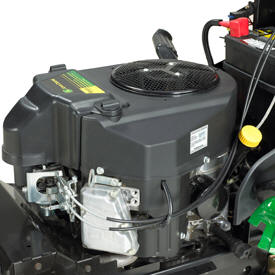 18.5-hp (13.8-kW) V-twin engine
18.5-hp (13.8-kW) V-twin engine

The tractor is powered by a John Deere iTorque™ power system, a combination of engine features and an exclusive hood design that provides superior lugging ability, even cooling, and durability.
Key engine features include:
- 18.5 hp (13.8 kW)
- Large 603-cc displacement
- V-twin air-cooled design that provides smooth, quiet power
- Quality features include:
- Cast-iron cylinder liners
- Overhead valves
- Full-pressure lubrication
- Replaceable oil filter
- Dual-stage air cleaner
- V-twin design:
- Excellent power and performance
- Easy starts
- Smooth operation
Flywheel alternator
A flywheel alternator provides plenty of capacity to quickly recharge the battery and power electrical equipment, such as lights or a sprayer:
- 15-amp capacity
- Regulated to keep the battery at full charge without risk of overcharging
Fuel tank has large, 3.3-U.S. gal. (12.5-L) capacity
 Fuel tank
Fuel tank
 Electronic fuel gauge
Electronic fuel gauge
Large fuel tank and convenient fuel gauge minimize the number of stops for fuel and chance of running out of fuel:
- Fuel tank has a large, 3.3-U.S. gal. (12.5-L) capacity for more hours of operation between refills.
- Large, 3-in. (7.6-cm) diameter fuel tank filler opening makes adding fuel easy.
- Located on the left fender
- Helps eliminate spillage
- Electronic fuel gauge on the dash display allows the operator to easily monitor the amount of fuel in the tank.
The 42-in. (107-cm) Accel Deep™ (42A) Mower Deck cuts clean and is versatile
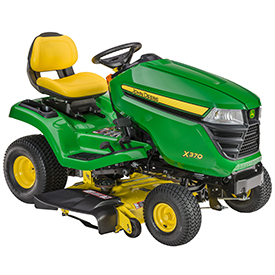 X370 with Accel Deep 42A Mower
X370 with Accel Deep 42A Mower
 Accel Deep 42A Mower
Accel Deep 42A Mower
The 42-in. (107-cm) Accel Deep Mower Deck provides the performance advantages of a two-spindle mower in a wide 42-in. (107-cm) size:
- Resilient four-point mounting system suspends mower from tractor for a smooth and level cut
- Wide mower wheels easily adjusted just above ground level to help prevent scalping
- 0.25-in. (6.4-mm) cut-height increments allow mower to be set at the desired cut height
- Onboard deck-leveling system makes keeping mower properly adjusted easy
- Compatible with optional MulchControl™ mulching system
- Compatible with efficient 7-bu (247-L) two-bag cut-and-throw material collection system
- For use on X330, X350, X354, and X370 Tractors
The 42-in. (107-cm) Accel Deep mower deck is a stamped-steel, deep, flat-top design that delivers excellent cut quality, productivity, cleanliness, durability, and versatility. Optimal performance and dispersion of clippings is provided, even at faster mowing speeds:
- 4.97-in. (12.6-cm) depth throughout the entire deck shell for optimum mowing, mulching, and bagging performance
- Optional lever-action or electric one-touch MulchControl attachment for superior mulching performance and versatility
- Stamped-steel design eliminates sharp edges and corners where material can build up and diminish mowing performance
- Mower deck suspended from the vehicle for a smooth and level cut
- Adjustable mower wheels, positioned just above ground level, for reduced scalping
Excellent cut quality
 42A Mower
42A Mower
 42A Mower
42A Mower
Deep mower-deck stamping gives excellent cut quality. It allows the cut and suspended material room to exit the deck without getting recut:
- Reducing the amount of re-cutting enables more power to be used to cut incoming grass, which greatly improves mower capacity.
- Helps maintain excellent cut quality at faster mowing speeds
- Clean flow of material out of discharge area prevents cut material from interfering with cutting the incoming grass, making it possible for the blades to cut incoming material cleanly.
- Even in mulching mode, cut evenness is improved compared to other designs because the additional depth allows for continuous circulation, optimal re-cutting, and an even distribution of clippings.
Productivity - gets the job done fast
 Side-discharge chute on Accel Deep 42A Mower Deck
Side-discharge chute on Accel Deep 42A Mower Deck
Deep mower-deck stamping gives high productivity, which gets the job done fast. It allows the cut and suspended material room to exit the deck quickly, reducing the amount of re-cutting so more power is available to process incoming grass:
- Greatly improves mowers capacity to maintain excellent mowing performance in difficult mowing conditions and at higher speeds
Large discharge opening is both high and wide to handle more material:
- Gives a smooth, even discharge of clippings at all mowing speeds
- Reduces the chance of plugging, especially important when operating in wet, thick, or dense grass and when bagging
- Cut-and-throw chute has a large, optimized inlet which aids in collecting material by using airflow from the large deck opening
Cleanliness - for the mower and the operator
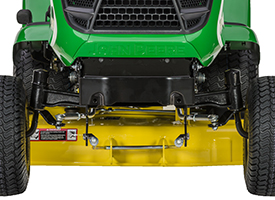 Accel Deep 42A Mower Deck
Accel Deep 42A Mower Deck
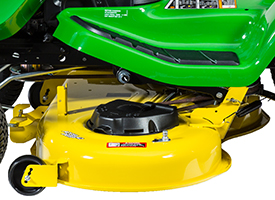 Accel Deep 42A Mower Deck
Accel Deep 42A Mower Deck
The flat-top shape of the deck stamping is optimal for keeping itself and the operator clean:
- There are few places to catch and hold material on top and underneath the deck.
- Top of deck stays cleaner, reducing time and effort needed for cleaning and service
- Underside of deck is self-cleaning to maintain optimum performance without buildup of material to interfere with the flow of air and clippings
- Less need to clean and remove buildup of material from underside deck
- The depth of the Accel Deep mower deck minimizes the amount of material that escapes from the front of the deck
- Limited amount of material to drift onto the operator and mower deck
- Even flow of material discharged out the chute, less re-cutting results in larger pieces that are less likely to end up on the operator
- Mulching prevents the discharge of material completely and a MulchControl attachment makes mulching a practical solution for most mowing situations.
Cleaning a mower deck, both top and bottom, is one of the most frequent maintenance activities:
- The flat-top design reduces places for material to build up and makes material that does collect easy to remove.
 Mower wash port
Mower wash port
 Mower wash port with hose connector
Mower wash port with hose connector
A wash port is provided to make cleaning the underside of the mower deck easy.
- Hose connector is included with the mower deck.
Superior durability is designed in
 Hinged spindle pocket cover on the 42A Mower
Hinged spindle pocket cover on the 42A Mower
 Mower wheels are double-captured for durability
Mower wheels are double-captured for durability
The 42A mower deck has strong spindle pockets, to keep the blades aligned, even after years of tough service:
- Ribs in the deck shell add strength where it is needed.
- The 42A has a 16 percent heavier overall weight than the Edge™ Xtra 42-in. (107-cm) mower deck.
Mower wheels are double-captured:
- Provides greater strength and durability for longer, trouble-free life.
- Single-bolt adjustment makes setting wheels to the correct height for the cutting height quick and easy.
Low-tension belt-drive design reduces the side load on the engines lower bearing and mower deck bearings for longer life.
Rolled outer edge of the deck provides extra strength and protection.
Dual-stage E-coat and powder-paint coatings provide extra protection from rust.
Versatility - easy to change between side discharge, mulch, and bagging modes
 Rear MulchControl baffle (A) that must be removed for bagging
Rear MulchControl baffle (A) that must be removed for bagging
 Rear MulchControl baffle removed to allow for chute installation
Rear MulchControl baffle removed to allow for chute installation
The 42A Mower Deck is designed for excellent versatility:
- The mower's cut-and-throw design allows bagging with just the addition of the bagger chute, once the special bagging blades have been installed.
- The 42A cut-and-throw chute is easy to install and securely held in place at the front and rear to provide a tight seal between the mower deck and the chute.
- The rear latch is adjustable to allow for the optimum setting for easy use and a tight seal.
- The bagging blades can be used for side discharging also.
- The 42A cut-and-throw chute is easy to install and securely held in place at the front and rear to provide a tight seal between the mower deck and the chute.
- With an optional lever action or electric one-touch MulchControl attachment installed (along with the special mulching blades), changing from side-discharging to mulching or vice versa is done with the simple flip of a lever or touch of a switch.
- The rear bagger can be used with the MulchControl blades installed.
- The front baffle, either the one included with the rear bagger chute or the one included with MulchControl (B), can remain in place for side discharging.
- For ultimate side-discharge performance this baffle can be removed.
- An optional MulchControl attachment includes a rear MulchControl baffle (A), held in place by two carriage bolts, at the rear edge of the discharge opening. This baffle:
- Must be removed for installation of the rear bagger chute, a 13-mm (0.51-in.) wrench is required (the bagger chute cannot be installed without removing this baffle)
- Can remain removed for side discharging material
- Must be re-installed for mulching
MulchControl lever action or electric one-touch options
A MulchControl attachment for the 42A Mower Deck makes mulching more practical for many mowing situations because it not only does an excellent job of mulching but it also allows the mower to be easily converted for times when it is more desirable to side discharge the lawn material. Advantages of mulching grass clippings include:
- A beautiful looking lawn
- Grass clippings not blown onto the operator, driveways, or flower beds
- Less fertilizer use
- Elimination of the effort needed to dispose of clippings
How MulchControl works
 MulchControl baffle open
MulchControl baffle open
 MulchControl baffle closed
MulchControl baffle closed
MulchControl is an innovative, simple design that is easy to use and maintain:
- The MulchControl attachment includes baffles to control the flow of material under the deck.
- When the MulchControl baffle is open, most of the material passes through the discharge opening.
- When the MulchControl baffle is closed, the material stays within the deck and gets chopped into mulch and deposited in the turf.
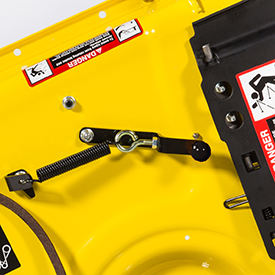 Lever action MulchControl handle
Lever action MulchControl handle
 Electric one-touch MulchControl switch
Electric one-touch MulchControl switch
- With the lever-action MulchControl attachment, the MulchControl handle on top of the mower deck is used to engage or disengage mulch mode.
- The operator is required to get off of the tractor in order to engage or disengage mulch mode with the lever-action system.
- With an electric one-touch MulchControl attachment, an electric switch on the tractor dash is used to engage or disengage mulch mode.
- Changing from mulching to side discharging or vice versa takes only a few seconds.
MulchControl is well-suited to the following mowing situations:
- Usually mulch, but side discharge when grass gets too long
- Usually side-discharge, but would like to be able to close the chute to control clippings
- Always mulch a main lawn, but often side discharge secondary lawns
- Bag clippings, but want to go farther before emptying bags
MulchControl limitations
While in the side-discharge mode, MulchControl will still mulch about one third of the material. Therefore, the side-discharge mode is essentially a partial-mulch mode. This can be an advantage when side discharging or bagging, as it helps to reduce the amount of material being discharged. Other times this could work as a disadvantage:
- When cutting strong southern grasses, such as Zoysia and Bermuda
- When cutting in wet, high-growth conditions, such as those found in the Pacific Northwest United States
- When optimum bagging and lawn clean-up is desired
- 42A Mower Deck requires a MulchControl baffle be removed to install the bagger chute; see explanation in the Versatility section for more information
7-bu (247-L) rear bagger
 Optional rear bagger
Optional rear bagger
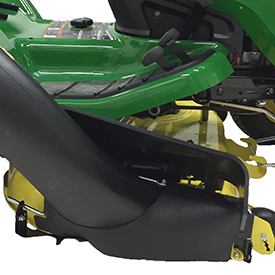 Lower chute installed
Lower chute installed
An optional 7-bu (247-L) cut-and-throw rear bagger material collection system (MCS) is available for use with the 42-in. (107-cm) Accel Deep Mower. It provides an efficient means of collecting grass clippings and leaves.
The hopper design provides modern styling, great bagging performance, cleaner operation, and easy-to-empty bags:
- 7-bu (247-L) capacity
- Easy-to-attach lower chute (ordered separately)
- Air exhaust duct
- Convenient spring-latch
- Airflow fill indicator
- Quik-Tatch mounting
- Sealed hopper top
- Loose-knit bags available
Mower blades
 Mower blades shipped with the rear bagger chute
Mower blades shipped with the rear bagger chute
High-lift bagging blades are included with the bagger chute. They provide optimum performance when bagging in difficult conditions, such as when the grass is moist, dense, or long:
- High-lift bagging blades also work well when side discharging material.
Mulching blades are included with the MulchControl attachment. They can be used for mulching, side discharging, and bagging in most conditions.
Mower blade use chart
| Mode(s) of operation | Mower blade |
| Side discharging mode only | M170639 side-discharge blade (shipped with mower) |
| Bagging mode only | GX25668 bagging blade (shipped with BG20754 rear bagger chute) |
| Mulching mode only | M170642 mulching blade (shipped with BM24794 lever-action and BUC10164 electric one-touch MulchControl) |
| Side discharge and mulching | M170642 mulching blade (shipped with BM24794 lever-action and BUC10164 electric one-touch MulchControl) |
| Side discharge and bagging | GX25668 bagging blade (shipped with BG20754 rear bagger chute) |
| Side discharge, mulching, and bagging | M170642 mulching blade (shipped with BM24794 lever-action and BUC10164 electric one-touch MulchControl) |
Four-year or 300-hour bumper-to-bumper warranty is standard
An exclusive 4-year or 300-hour (whichever comes first), single-source, bumper-to-bumper warranty* is standard for all John Deere X300 Series Tractors.
- The warranty is hassle free, with one company handling all of the paperwork.
- Premium features of X300 Series Tractors allow for this longer warranty period, with more coverage than comparable tractors.
*Term limited to years or hours used, whichever comes first, and varies by model. See the LIMITED WARRANTY FOR NEW JOHN DEERE TURF AND UTILITY EQUIPMENT at JohnDeere.com or JohnDeere.ca/TUWarranty for details.
Lever-action or electric one-touch MulchControl™ options are available for extra mowing convenience
 Lever-action MulchContol lever
Lever-action MulchContol lever
 Electric one-touch MulchControl switch
Electric one-touch MulchControl switch
Lever-action or electric one-touch MulchControl attachment is available for Accel Deep™ 42-in. (107-cm) (42A), 48-in. (122-cm) (48A), and 54-in. (137-cm) (54A) Mower Decks used on X300 and X500 Select Series™ Tractors.
MulchControl advantages and benefits
MulchControl enhances versatility and productivity. A mower deck equipped with MulchControl not only does an excellent job of mowing and mulching, but it can also be quickly converted from side discharging to mulching or vice versa:
- In mulch mode, it controls clippings dispersion in unwanted areas (driveways, landscape beds, near buildings, windows, parking lots, etc.).
- Reduces cleanup time needed to dispose of clippings.
- Reduces the amount of material entering a material collection system because, even in the side discharge mode, MulchControl will mulch about one third of the material due to the additional baffles under the mower deck and the unique design of the mulching blades.
Electric MulchControl has the additional advantage of being controlled from the tractor seat by a switch on the dash to operate an electric actuator that moves the baffle to close off the discharge area of the mower deck.
 Electric one-touch MulchControl switch
Electric one-touch MulchControl switch
 Electric one-touch MulchControl actuator
Electric one-touch MulchControl actuator
- Operators can convert between modes without interrupting the mowing process, making it practical to change between modes as conditions require.
- When approaching clean areas like driveways or flowerbeds where clippings would be undesirable
- When a breeze might blow clippings back onto the operator
- For side discharge mowing only the areas of the property where grass is too thick for mulching
- With 48A and 54A Mower Decks, for collecting only the areas of the property where grass is too tall or thick for mulching
- With 48A and 54A Mower Decks, the MulchControl baffle can be opened or closed with the Power Flow™ blower installed. The Power Flow blower will run without material when the baffle is closed.
- Models equipped with a 42A Mower Deck require a MulchControl baffle be removed to install the bagger chute; see 42A Mower Deck versatility explanation for more information.
- Changing from one mode to the other takes only a few seconds.
How MulchControl works
A mower equipped with a MulchControl attachment delivers unprecedented levels of productivity and versatility. The operator has the ability to quickly change between side discharging and mulching. A heavy-duty baffle opens and closes to convert the mower from side discharge mode to mulch mode or vice versa.
 MulchControl baffle open (similar mower deck shown)
MulchControl baffle open (similar mower deck shown)
 MulchControl baffle closed (similar mower deck shown)
MulchControl baffle closed (similar mower deck shown)
MulchControl is an innovative, simple design that is easy to use and maintain:
- The MulchControl attachment includes baffles to control the flow of material under the deck.
- When the MulchControl baffle is open, most of the material flows freely out the discharge deflector or into a material collection system.
- When the MulchControl baffle is closed, material stays within the deck and gets chopped into mulch and deposited in the turf.
MulchControl is well-suited to the following mowing situations:
- For operators who usually mulch, but side discharge when grass gets too long
- For operators who usually side discharge, but would like to be able to close the chute to control clippings in some areas
- For operators who always mulch a main lawn, but often side discharge secondary lawns
- For operators who collect clippings, but want to go farther before emptying the material collection system
MulchControl puts the operator in control of the clippings. The operator can have all the benefits of mulching with the ability to easily change to side discharging when desired.
Advantages of MulchControl include:
- Performance is improved.
- Mulching is beneficial because it returns the clippings to the ground as fertilizer, which promotes lawn growth.
- Clippings are much smaller, which allows them to fall into the grass and be removed from view.
- Unsightly grass clippings are not blown onto driveways or into flower beds.
- Fertilizer use is reduced and provides associated environmental benefits.
- Uptime is increased.
- Operators can convert quickly between modes, making it possible to change between mulching and side discharging as conditions require.
- Mulching heavy, thick material can significantly reduce mower productivity. The ability to switch from mulch to side discharge mode ensures productivity, especially in grass too tall or thick to mulch effectively.
- Cost of operation is reduced.
- Controlling clipping dispersion reduces cleanup time.
MulchControl limitations
While in the side discharge mode, MulchControl will still mulch about one third of the material. Therefore, the side discharge mode is essentially a partial mulch mode. This can be an advantage when side discharging or bagging, as it helps to reduce the amount of material being discharged. Other times this could work as a disadvantage:
- When cutting strong southern grasses, such as Zoysia and Bermuda
- When cutting in wet, high growth conditions, such as those found in the Pacific Northwest United States
- When optimum bagging and lawn cleanup is desired
- 42A Mower Deck requires a MulchControl baffle be removed to install the bagger chute
MulchControl compatibility
Each MulchControl attachment includes everything needed: baffles and mulch blades for all attachments, and the actuator, wiring, and switches for the electric one-touch attachments.
Lever-action MulchControl attachments
| Attachment number | Description | Applications |
| BM24794 | 42A MulchControl (lever action) | X300 Series Tractors, Z300 Series ZTrak™ Mowers |
| BM24993 | 48A MulchControl (lever action) | X300 and X500 Series Tractors, Z300 and Z500 Series ZTrak Mowers |
| BM24994 | 54A MulchControl (lever action) | X300 and X500 Series Tractors, Z300 and Z500 Series ZTrak Mowers |
Electric one-touch MulchControl attachments
| Attachment number | Description | Applications |
| BUC10164 | 42A electric one-touch MulchControl | X300 Series Tractors* |
| BUC10165 | 48A electric one-touch MulchControl | X300 and X500 Series Tractors* |
| BUC10166 | 54A electric one-touch MulchControl | X300 and X500 Series Tractors* |
* NOTE: Model year 2016-2017 X300 and X500 Series Tractors (X300 serial number 10,001-50,000 and X500 serial number 110,001-130,000) require replacing the tractor wiring harness and dash panel to use an electric MulchControl attachment.
Snow removal is a strength of lawn tractors
 44-in. (112-cm) Front Blade
44-in. (112-cm) Front Blade
 Snow blower, weather enclosure, and chains on an X300 Series Tractor
Snow blower, weather enclosure, and chains on an X300 Series Tractor
An advantage of lawn tractors is their ability to use equipment for snow removal. Lawn tractor owners can add a John Deere snow blower or front blade to make quick work of moving snow whenever the need arises. Weather enclosure and tire-chain attachments add comfort and performance.
Equipment available for snow removal includes:
- 44-in. (112-cm) Snow Blower
- 44-in. (112-cm) Front Blade
- 48-in. (122-cm) Front Blade (X394 Tractor only)
- Tire chains or TerraGrip traction belts
- Weather enclosure (available for all X300 Series, except the X350R)
- Weights
Steering is low-effort sector and pinion system
 Tight turning radius
Tight turning radius
 Designed for easy turns
Designed for easy turns
A heavy-duty sector and pinion steering system with quality bearings provides easy and precise control for the life of the tractor:
- Small, 16-in. (40.6-cm) turning radius provides excellent maneuverability
- Tight turning ability improves mowing efficiency
Easy steering
Easy steering is important for an enjoyable mowing experience:
-
Large, 14-in. (36-cm) diameter steering wheel for improved leverage
-
Large sector gear for improved (higher) steering ratio
-
A higher ratio equals lower steering effort
-
-
Dual drag links to help equalize the steering loads and reduce steering error
-
Ball joints on both ends of the steering tie rods for long life
-
Long steering arms to improve the mechanical advantage of the steering system through the full range of motion
- Sector gear that pivots on a shaft rather than a bushing to ensure proper gear mesh and eliminate binding
- Greaseable front steering spindles to reduce friction and improve wear over time
Integrated hydrostatic transaxle efficiently transmits power to wheels
 Kanzaki® K46 transaxle (X330, X350, X354) Kansaki K57 transaxle (X370)
Kanzaki® K46 transaxle (X330, X350, X354) Kansaki K57 transaxle (X370)
 Kanzaki K58 transaxle (X380, X384, X390, X394)
Kanzaki K58 transaxle (X380, X384, X390, X394)
The Tuff Torq® hydrostatic transaxle encloses the hydrostatic pump and motor rotator groups in the same housing with the differential and axle housings. This design is very efficient and reduces the number of sealing surfaces to minimize the potential for leakage.
Combined with the foot controls, the hydrostatic transmission functions similarly to that of an automatic transmission in an automobile, so the term automatic is often used to describe it:
- Use of the latest valve designs has significantly reduced the sound level.
- Large pump and motor rotating groups ensure long life and efficient operation.
Freewheeling valve
 Freewheeling valve
Freewheeling valve

A freewheeling valve control is conveniently located near the tractor rear hitch plate for good visibility and easy operation.
Kanzaki and Tuff Torq are trademarks of Kanzaki Kokyukoki Manufacturing Company.
Controls and display functions are easy to identify and convenient to use
 X394 Tractor mowing
X394 Tractor mowing
 Steering wheel and controls (switch turned on to show display)
Steering wheel and controls (switch turned on to show display)
Controls
The contoured dash has clean, attractive styling and ergonomic controls for easy use:
- Controls are color coded and labeled with English words for easy identification by the operator.
- Controls are logically placed and easy to reach.
- The power take-off (PTO) switch allows the operator to get fingers underneath it, like a T-handle, to pull up for easy activation.
- The reverse implement option (RIO) switch is a yellow button.
- The latch control on foot-lift models and hydraulic-lift control on power-lift models and the park brake latch are pivot levers for low effort.
- Cruise control activation is handled by an automotive-style button.
- Separate engine speed and choke controls make starting and warming up the engine easier in cold weather.
- The choke lever is spring loaded to eliminate the chance the tractor will be unintentionally operated with the choke partially closed.
- Functional design of the throttle and choke controls provides good appearance and a comfortable feel.
Display panel
 Display panel
Display panel
 Display panel illustration with descriptions
Display panel illustration with descriptions
Instrument display has the look and feel of a modern automobile. A power-up sequence cycles lights and gauges to indicate they are working:
- Display features dark-cockpit design to minimize operator distractions.
- Display is back lit for night visibility.
- Night visibility is especially useful with snow blower use.
- Hour meter makes it easy to tell when oil changes and other maintenance should be performed.
- Electronic fuel gauge provides real-time fuel level information.
- The X350R has a low fuel light, rather than a fuel gauge, to provide the operator with a noticeable warning when low on fuel.
- A tachometer graphically displays engine speed.
- Target-zone graphics inform the operator of the engine speed range to use for best cut quality.
- An indicator tells the operator when the PTO is operating.
- Bright caution and stop lights capture the operator's attention when important information is on the instrument cluster.
- Damage can be prevented and repair costs reduced by addressing problems early.
- Operators are advised of what the problem is if they attempt to operate the mower with unsatisfied PTO, seat, or park brake interlocks.
- The indicators are also useful to identify the reasons the PTO or engine may have shut off when an interlock is unsatisfied.
- Operators are advised if battery voltage is low, normal, or excessive.
- The service indicator light illuminates to indicate a diagnostic error code is stored.
- Onboard diagnostics provides trouble codes for use by trained technicians.
- For example, a technician will be able to test switch functionality and circuit continuity without tools.
- Onboard diagnostics provides trouble codes for use by trained technicians.
 Storage tray under tractor seat
Storage tray under tractor seat
 Exact Adjust tool is used to level mower deck
Exact Adjust tool is used to level mower deck
Storage for the onboard deck-leveling gauge and the Exact Adjust tool is provided in the storage tray under the tractor’s seat:
- Exact Adjust ports on the fender deck allow for easy and accurate leveling of the mower deck for optimum mowing performance.
Twin Touch™ foot control
 Twin Touch foot control
Twin Touch foot control
 Cruise control
Cruise control
Twin Touch foot pedals control the speed and direction of travel:
- Automotive-type accelerator control ensures easy operation.
- Operator can change direction without lifting foot off the platform.
- Large pedal surface gives superior operator comfort.
Cruise control
Cruise control is standard equipment:
- To engage, push the cruise-control button and hold until the foot is removed from the forward pedal.
- For emergency stop, the cruise control can be released by pushing on the brake pedal or the forward pedal.
Mower deck height adjustment
 Conveniently-located deck height adjustment knob
Conveniently-located deck height adjustment knob
 Cut height adjusting knob
Cut height adjusting knob
A rotary dial knob makes adjusting the mower cut height quick and easy:
- Provides mower cut heights in 0.25-in. (0.64-cm) increments from 1 in. (2.5 cm) to 4 in. (10.2 cm)
- Returns the mower deck to the same preset height each time it is lowered
 Deck-leveling gauge placed under deck
Deck-leveling gauge placed under deck

Deck-leveling gauge is placed at the appropriate location under the left rear, right rear, and front of the mower deck as the cut height is adjusted using the Exact Adjust tool and front draft arm adjusting nuts.
Foot-pedal lift system
 Foot-pedal lift system
Foot-pedal lift system

Pushing with the foot to raise the mower or implement is less strenuous for many operators than using a hand-lift lever:
- The easy-to-use raised position lock operates similarly to the park brake lock.
- The foot pedal is out of the way and not likely to catch on bushes and tree limbs when mowing.
- The mower deck returns to the same preset height each time it is lowered.
Adjustable lift-assist spring
 Lift-assist spring decals and adjusting bolt
Lift-assist spring decals and adjusting bolt
 Close-up of lift-assist spring decal
Close-up of lift-assist spring decal
NOTE: The adjustable lift-assist spring is standard equipment on tractors with manual foot-lift system that are shipped with the 48-in. (122-cm) and 54-in. (137-cm) side-discharge mowers, and an option for tractors shipped with 42-in. (107-cm) mowers. It is a recommended option for foot-lift tractors sold with the 42-in. (107-cm) mulch mower.
- Lift-assist spring is provided on tractors shipped from the factory with a 48-in. (122-cm) or 54-in. (137-cm) side-discharge mower deck, except models with hydraulic lift, and a recommended option for tractors equipped with a 42-in. (107-cm) mulch mower to minimize lift effort.
-
A spring-assist kit is available for other models for use with front equipment.
-
-
Lift effort can be easily adjusted by turning a bolt, located on the tractor front bumper, for optimum performance, depending on the equipment used (mower, front blade, snow blower, etc.).
-
The mower will not be inadvertently locked in the raised position when mowing through ditches.
-
When installing or removing a mower or front equipment raised by the foot-lift system, spring tension may be removed from the connection points by pulling rearward on the lift pedal and raising the lift latch to hold the pedal in the rearward position.
Parking brake control
 Parking brake
Parking brake
Depressing the brake pedal applies internal wet-disk brakes, which provide better reliability and longer life than external brakes, for safe stopping.
The parking brake control is conveniently located for easy access. It holds the brake pedal securely in the locked position.
Using RIO
CAUTION: Children or bystanders may be injured by rotating blades. Before traveling forward or rearward:
- Carefully check the area around the machine.
- Disengage the mower before backing up.
NOTE: Operating the mower while backing up is strongly discouraged. RIO should be used only when operating another attachment or when the operator deems it necessary to reposition the machine with the mower engaged.
- Stop forward travel. Allow attachment to run.
- Look down and behind the machine to be sure that there are no bystanders.
- Push and hold in the reverse implement switch while depressing the reverse pedal slightly.
NOTE: If the attachment stops while positioning the machine, return mower engagement (PTO) switch to off position. Repeat this procedure from the beginning. - Release the reverse implement switch and reposition the machine as the machine begins to move rearward.
- Resume forward travel. The attachment should continue operating.
- Repeat procedure to position the machine again.
Reverse implement option (RIO)
 Reverse implement switch
Reverse implement switch
 Mower engagement power take-off (PTO) switch
Mower engagement power take-off (PTO) switch
Electric power take-off (PTO) clutch is easy and convenient to use
 Electric PTO switch
Electric PTO switch
The heavy-duty electric PTO clutch is operated with a convenient dash-mounted switch.
Heavy-duty PTO clutch
 PTO clutch
PTO clutch
The PTO clutch is designed to operate through many on/off cycles.
Frame is reliable heavy-duty welded steel
 Welded, heavy-duty frame
Welded, heavy-duty frame

The frame is made of heavy formed and welded steel, reinforced in critical areas for even greater strength:
- The frame is formed from 12-gauge, 0.105-in. (2.66-mm) thick material for long life.
- Standard front bumper and hitch plate are formed from 9-gauge, 0.15-in. (3.8-mm) steel and complete the frame assembly.
- Rear hitch plate can support two 42-lb (19-kg) Quik-Tatch weights.
- Weight bracket is built into the frame of two-wheel-steer models.
- Four-wheel-steer models require the optional weight bracket.
Front axle and wheel spindles are heavy-duty
 Cast-iron front axle
Cast-iron front axle
Front axle is made of nodular cast iron:
- Cast-iron front axle is strong and shock-resistant.
- Cast iron will not yield under heavy loads or impact.
A replaceable bushing is used at axle mounting:
- The bushing provides excellent wear resistance.
- Grease fittings at each spindle are easy to service.
Front steering spindles
 Steering spindle
Steering spindle
Front steering spindle diameter is 0.75 in. (19 mm) for strength and long life:
- Have strength to handle heavy implements
- Provide long life at bearing surfaces
- Use sealed precision bearings in front wheels
Rear equipment-mounting system is heavy-duty and easy to use
 Rear equipment mounting system
Rear equipment mounting system
A heavy-duty equipment mounting system is used:
- Includes strong frame mounts with a combination of mounting holes in the tractor hitch plate that accept pins or shoulder bolts to support heavy rear-mounted equipment.
- Easily attach optional equipment to the tractor
- Can bear the load of heavy rear-mounted equipment, such as material collection systems
Modern styling with functional design enhances appearance and performance
 Attractive styling
Attractive styling
 Hood air-intake louvers
Hood air-intake louvers
Smooth, rounded contours present a modern, styled appearance:
- Hood styling incorporates efficient full-length air-intake louvers on each side, rather than on the top.
- Cooler engine operation
- Lower operator station sound levels
- Hot air is vented out the front grille, away from the operator.
- The fully enclosed hood is made of molded-in-color material.
- Reduces sound
- Will not rust or dent
- Distinctive grille and large, one-piece fender deck complete the styling package.
Two high-quality headlights give excellent visibility
 Optimum lighting pattern
Optimum lighting pattern
Headlights are standard equipment on all models:
- Two 27-W bulbs provide excellent lighting for good visibility during evening operation.
- A headlight position on the ignition switch makes it easy to operate the headlights.
- The headlights are designed to provide an optimum lighting pattern for mowing and snow removal.
Operator station is comfortable and convenient
 Operator station
Operator station
 Operator station
Operator station
The operator station is designed for operator comfort and ease of using controls:
- A large, 14-in. (36-cm) diameter steering wheel is comfortable to use and minimizes steering effort.
- Full-length foot mats provide comfort for the operator and protect the footrest area.
Comfortable seat
 Comfortable open-back seat
Comfortable open-back seat

An open-back 15-in. (38-cm) high-back seat provides a comfortable, smooth ride and good support for the operator:
- Seat travel of 7 in. (18 cm) with 15 positions allows the operator to be seated comfortably and easily operate the controls.
- Seat can be easily adjusted fore and aft by the operator while sitting on the seat.
- Open-back design allows air circulation to keep the operator's back cool and dry for a more comfortable ride.
- Grasp at the top of the seat is conveniently located for use when tilting the seat up to protect it from the weather.
Seat suspension
 Seat suspension
Seat suspension

The seat suspension is adjustable, without tools, for the weight of the operator:
- Springs are adjustable fore and aft to any of three positions.
- No tools require
- Allows fine-tuning of the suspension for the operator's weight
- Back position for more support for heavier operators
- Tool tray is designed into the seat base.
- Can be used to store gloves, small tools, etc.
- Provides storage location for Exact Adjust tool and deck-leveling gauge (tool and depth-leveling gauge not shown in photo)
Cup holder
 Cup holder and tool tray on fender
Cup holder and tool tray on fender
A cup holder and tool tray are located on the fender for operator convenience:
- The cup holder holds a variety of container sizes.
- Tool tray provides convenient storage.
- Cup holder and tool tray are constructed of durable acrylonitrile butadiene styrene (ABS) plastic.
Removable plug for optional 12-V outlet
 Location for optional 12-V outlet
Location for optional 12-V outlet
A removable plug on the console, in front of the operator, provides a convenient location for the optional 12-V outlet and makes installation easy.
- Convenient for plugging in cell phone charger and other electric devices
- Can be used to operate electric rear equipment, such as a sprayer or spreader
12-V fast connector
 Illustration of fast connector location
Illustration of fast connector location
A mid-vehicle, 12-V fast connector, located under the tractor’s fuse box, is included as standard equipment to reduce initial installation time for some attachments that operate on 12-V power from the tractor:
- The four-cavity connector includes battery, ground, and key switch terminals and is turned on and off with the ignition switch.
Serviceability is convenient with easy-open hood
 One-piece hood is easy to open
One-piece hood is easy to open
 Service interval decal located under hood
Service interval decal located under hood
The one-piece hood opens easily to permit checking and servicing the engine:
- Important service points are located within easy reach.
- A service-interval decal is provided inside the tractor hood for convenience when servicing the tractor.
- The high-quality engine used in the X300 Series does not require an 8-hour oil and filter change because improvements in the manufacturing process and quality of parts, components, and oils have eliminated the need for the short interval oil change requirement.
 Easy-to-service engine fuel and oil filters
Easy-to-service engine fuel and oil filters
The engine fuel and oil filters, the oil check/fill tube, and the oil drain tube are exposed for serviceability when the hood is opened.
Exact Adjust ports and onboard deck-leveling tools make precise deck adjustments easy
 Deck-leveling gauge and hex adjusting tool stored under tractor seat
Deck-leveling gauge and hex adjusting tool stored under tractor seat
 Exact Adjust access holes
Exact Adjust access holes
A mower deck must be level side-to-side and properly adjusted front-to-rear to give the best cutting performance. A removable onboard deck-leveling gauge and a hex-key tool are provided to make adjustment easy. They are securely stored under the tractor seat.
Exact Adjust leveling ports are provided on each side of the operator platform above the mower-level adjusting bolts. With the hex-shaped tool, they provide convenient access to allow quick and easy adjustment of the mower for the best-cut quality of cut.
The Exact Adjust feature is standard on all Select Series™ X300 and X500 Tractors:
- There is no need to reach under the fender deck while making the mower-level adjustment.
- Onboard deck-leveling gauge, Exact Adjust ports, and the hex tool work together.
- Level the mower deck side to side
- Set the correct amount of rake (front-to-back deck orientation)
- Calibrate the cutting height to the cut-height adjusting knob setting
- Exact Adjust simplifies leveling the mower deck if equipped with a Power Flow™ blower.
- To give the best cut, mower level should be adjusted if alternately mowing with and without blower installed. The Exact Adjust feature makes this easy.
 Deck-leveling tool placed under deck
Deck-leveling tool placed under deck
 Using included ball-hex tool to level mower deck
Using included ball-hex tool to level mower deck
Consult the operator's manual for the correct adjusting procedures for each tractor model. Basic adjusting steps to properly level the mower deck include:
- Park the tractor on a level surface.
- Inflate tires to the correct pressure.
- Consult the label for the cutting-height knob that is located on the console of the machine. This label shows deck-leveling position and location of deck-leveling adjustment points.
 Cut height adjusting knob
Cut height adjusting knob
- Set mower cutting-height knob to the correct deck-leveling position.
- For X300 models, use position 2.75
- For all other models, use position 2.5
- Adjust mower wheels as necessary so they do not contact the ground surface.
- Remove the onboard deck-leveling gauge that is located under the seat.
- Using the Exact Adjust ports and tool, adjust mower deck side-to-side level so the deck-leveling gauge just slips under the left and right lower deck rim at the designated adjustment points. The location of adjustment points will vary slightly between decks.
- Left- and right-rear adjustment points are under the deck rim near the rear mower wheels, if equipped.
- Adjust mower deck front-to-back level, if necessary.
- Loosen rear nuts equally on each side of front lift rod.
- Turn front nut equally on each side clockwise to raise front of mower or counterclockwise to lower it until gauge just slips under the front adjustment point.
- Tighten rear nuts after adjustment is complete.
- Return the gauge to its storage position.
NOTE: The adjusting tool supplied with the tractor is an 8-mm ball-hex key, part number M162737. The rounded end allows for some misalignment with the bolt as the deck is adjusted.
The MowerPlus™ app helps maintain the tractor and lawn
 MowerPlus app screen
MowerPlus app screen
 MowerPlus app maintenance screen
MowerPlus app maintenance screen
Keep a John Deere riding lawn mower running its best and know how it mows with the John Deere MowerPlus app. Simply scan the lawn tractor’s barcode to get custom information. The app helps determine the best time to mow, communicates expert pre-mow tips, offers maintenance reminders, and provides walk-through guides.
Look for the MowerPlus app on the mobile device’s app store.
The app supports residential lawn equipment such as 100 Series, S240, X300, X500, X700, Z200 through Z600, and many similarly-sized older products. It does not presently support tractor models numbered 1000 and larger, such as 1025R.
NOTE: Some product image variation may exist.
Also available is the John Deere MowerPlus smart connector (sold separately).
 Smart connector
Smart connector
The John Deere MowerPlus smart connector wirelessly links a Select Series™ X300 or X500 Tractor to the MowerPlus app on a mobile device. The smart connector transmits engine usage to the app, making it easy to track maintenance intervals. It also transmits the fuel level to the app—when thinking ahead about Saturday morning mowing, the operator can make sure the tractor is fueled and ready to go.
Features
AutoTrac™ automatic guidance system
 5R Tractor with AutoTrac guidance system
5R Tractor with AutoTrac guidance system
John Deere guidance systems offer many benefits to the operator, including optimizing machine efficiency, reducing operator fatigue, and the ability to work at faster speeds.
AutoTrac is an assisted automated steering system that automatically steers the machine through the field.
AutoTrac
AutoTrac is an automated steering system that can be operated from 0.5 km/h to 30 km/h (0.3 mph to 18.6 mph).
- Straight track: operate in absolutely straight lines by defining a point A at one end and a point B at the other end of the field. Skipping lines for easy and fast turns at the headland is possible.
- Curve track: the curve track functions are available on all AutoTrac tractor models. In particular, when driving the first passes at the headland, the system follows the shape of the fields curves, driving curves with a constant or increasing radius and using AutoTrac at the headland after completing the first row.
- Markers: when a tank is empty, for example, the system marks this point in the field. After having filled up the tank, the display will guide the operator to the location they marked.
- Turning view: on the headland, the operator must manually steer the tractor close to the next pass and then press the resume switch. There is no need to place the tractor exactly on top of the beginning of the next row. This means saving time on the headland.
- Shift track: this function allows the operator to return to the field to finish work they started yesterday. Satellites move the whole time the operator is away and so the guidance line is not at the place from yesterday. The operator can press one of the shift track buttons to fix the line for the day’s work.
Benefits:
- Reduced implement overlap
- Greater field working speeds
- Reduced fuel and input costs
- Optimized machine efficiency
- Reduced operator fatigue
The tractor controllers process differential global positioning system signals from the StarFire™ receiver, the wheel angle sensor, and a steering wheel position sensor. It uses these signals to steer the tractor via the electrohydraulic steering valve. The steering wheel position sensor detects slight motion of the steering wheel. If the operator performs manual steering or leaves the seat, the system is shut off. To activate AutoTrac, simply press the Auto Resume switch to engage automatic steering.
 AutoTrac resume switch
AutoTrac resume switch
AutoTrac ready
The 5R Tractors can be equipped with an AutoTrac ready option from factory:
- GreenStar™/ISOBUS ready option
- Wheel angle sensor
- Electrohydraulic steering valve
- Steering wheel sensor
- Harnesses
AutoTrac Complete
AutoTrac Complete is a fully operational AutoTrac package ex-factory.
The 5R Tractors can be equipped with an AutoTrac Complete option from factory:
- AutoTrac ready (see AutroTrac ready section)
- Gen 4 4240 Universal Display
- StarFire 6000 Receiver
- Activation
 StarFire 6000 Receiver
StarFire 6000 Receiver
 4240 Universal Display
4240 Universal Display
NOTE: For more information on additional displays, receivers, and Precision Ag Technology products, refer to Precision Ag Technology product information.
NOTE: To use AutoTrac, a GreenStar display and StarFire receiver is required.
Industry-leading maneuverability
Utility tractor users often work in challenging environments, including in and around barns, fields, or livestock areas. Maneuverability is a priority as space can be limited at times. Implementing the single-piece mid-frame designs and the structural oil pan enabled the wheelbase of the 5R to shrink by 100 mm (4 in.) when compared to the Final Tier 4 (FT4) 5M Tractors.
 Single-piece mid frame
Single-piece mid frame
 Structural oil pan
Structural oil pan
The shortened 2250-mm (88.6-in.) wheelbase provides best-in-class turning with a 12.1 turning radius without the use of turning brakes. This calculation uses 13.6R24 front tires, which provide 58 degrees of turning angle and a full 10 degrees of axle oscillation.
CommandQuad™ Manual transmission provides fully electronic range and gear shifting
CommandQuad Manual transmission is base equipment on 5090R, 5100R, 5115R, and 5125R Tractors
The CommandQuad Manual transmission expands the proven reliability of the PowrReverser™ transmission with a 4-range, 4-speed transmission that enhances operator convenience and productivity through fully electronic manual range and gear shifting. The CommandQuad Manual uses the same final drives, rear axle, and differential as the already proven 5M PowrReverser transmissions. Rather than using mechanical synchronizers, the CommandQuad Manual utilizes powershift clutches. Also, electrohydraulic cylinders move the shift rails instead of a mechanical lever. This provides excellent ease of use and more efficient operation.
The CommandQuad Manual transmission is equipped with 16 forward and 16 reverse (16F/16R) speeds, a left-hand reverser, and four powershiftable gears in four fully synchronized ranges. The CommandQuad Manual transmission also comes with open centered hydraulics in base equipment, with the ability to option up to pressure and flow compensating (PFC) hydraulics from the factory. The base CommandQuad Manual transmission operates at speeds as slow as 1.9 kph (1.18 mph) with rolling circumference index (RCI) group 44 rear tires, and speeds up to 40 kph (25 mph).
For even slower speed options, a creeper is available as a factory-installed option (requires PFC hydraulics).
CommandQuad ground speed chart
CommandQuad with creeper ground speed chart
Operating the CommandQuad Manual transmission
 CommandQuad shift controls
CommandQuad shift controls
Range/gear controls
A single control lever, similar to the control used on the DirectDrive™ on 6R and CommandQuad™ on 7R, features an ergonomically designed and intuitive operator interface. This control lever provides manual gear and range change selection. This base transmission, although similar in operation to the optional Command8™ transmission, does not offer any automatic shifting capabilities.
Once the tractor is started, the operator selects a range by pressing one of the lettered range buttons on the right-hand console. The operator has five different selections to choose from - A, B, C, and two multi-range modes (BCD and CD). When a range with a single letter is selected, gear shifting is allowed within the specified range. When a range with multiple letters is selected, operators can shift between the designated ranges simply by using the toggle lever.
The gear within the range can be selected by using the transmission control toggle lever to electronically shift to a desired gear. After setting the desired throttle position, the operator can move the left-hand reverser to the forward or reverse position to start movement. The operator can shift up or down through the gears in the selected range(s) as needed.
The operator has the ability to shift through speeds and ranges without clutching by moving the toggle lever forward, toward the + indicator, or backward, toward the - indicator. A single movement of the toggle lever changes one gear at a time. Holding the toggle lever in either direction increases accelerates gear changes throughout the range at a faster pace.
When in a multi-range mode, a simple double toggle of the lever moves to the next range.
 Left-hand reverser
Left-hand reverser
Left-hand reverser
The electronic left-hand reverser is standard with all CommandQuad Manual transmissions and provides neutral-to-gear modulation, which allows a quick, convenient, and smooth forward-reverse shuttle shifting at any speed. The shifter must be lifted from either park or neutral position to forward or reverse to activate. The parking brake is also electronically controlled through the left-hand reverser.
The left-hand reverser is a great feature for loader tractors. The operator's left hand can control easily tractor direction while the right hand manages the loader joystick and speed changes.
Independent programmable forward/reverse ratio
This feature is helpful in cyclical operations, such as loader work, where the operator wants to control the forward speed as a ratio of the reverse speed.
In manual mode, the tractor automatically selects a gear closest to the ratio desired by the operator. In auto mode, the tractor would adjust the set speed in the opposite direction. Ratios can be programmed up to 100 percent faster than the forward speed or up to 80 percent slower than the forward speed within the cornerpost display. This is adjustable in 20 percent increments (forward speed x 0.20, 0.40, 0.60, 0.80, 1.00, 1.20, 1.40, 1.60, 1.80, 2.00).
Another selection is independent; in this mode the tractor remembers the last forward and reverse gear setting. Once the gear is manually changed in the reverse direction, the gear will automatically go back to the last gear when changing directions. If the gear is not manually changed when in reverse direction, then the forward gear and reverse gear will remain the same when changing directions.
While the maximum forward ground speed is 40 km/h (25 mph), the maximum reverse speed is 30 km/h (18.6 mph).
Standard advanced features of the CommandQuad Manual transmission
AutoClutch
With AutoClutch, which is standard on all 5R Utility Tractors, the operator no longer has to use the clutch to control braking and re-engagement of the tractor if so desired. The clutch pedal is still on the tractor for those operators that still prefer to manually foot clutch. This provides the ultimate in ease of use.
AutoClutch allows the operator to bring the tractor to a complete stop without clutching, while at the same time does not overload the engine. It also provides the ability to inch or creep the tractor forward or reverse on a level surface or incline. And it provides the ability to accelerate the vehicle back to normal speed when releasing the brake.
The operator can set the sensitivity setting of the AutoClutch system in the cornerpost display. There are three modes available:
- High sensitivity (default mode)
- Off – temporary setting only that is reset after a key cycle
- Low sensitivity
Low sensitivity would be typically used in transport applications with a towed implement. The low sensitivity ensures that the tractor and implement are stretched for better traction control.
Speed matching
When shifting ranges in a multi-range mode (BCD, CD), the transmission will shift to a gear that most closely matches the speed in the range from which the operator is shifting from, which improves operator comfort by making a smoother transition into a new range. There are two types of speed matching, passive and active.
With passive speed matching, when shifting to a new range, the tractor shifts to a selected fixed gear in the new range based on transmission ratios. For example, when shifting from C4 to D range, instead of shifting into D4 when the range is changed to D like a mechanically controlled transmission would do, the transmission shifts to a preset range and gear within range D. This most closely matches the transmission ratio from which the operator is coming from.
Active speed matching shifts up or down based on wheel speed during range shifts. This minimizes acceleration or deceleration when the clutch re-engages after a range shift and keeps a more consistent ground speed, improving operator comfort.
PowrReverser modulation
Similar to the 5M Utility Tractors, which offer a PowrReverser modulation dial to set aggressiveness of change in direction, all 5R Utility Tractors also offer PowrReverser modulation. Rather than a physical dial, the aggressiveness can be set through the cornerpost display. Settings can be set from 1 to 10, with 1 being the least aggressive direction change and 10 being the most aggressive direction change. A setting of 10 is popular for loader bucket applications where quicker directional changes are acceptable and more productivity is desired. Less aggressive modulation settings are ideal where smoother directional changes are required, such as bale stacking and pallet fork activities.
Start gear selection
Starting within gear 1 within every range has a negative impact on productivity. To minimize the amount of shifting required by the operator in many applications, start gears can be programmed by the operator when operating in any of the two multi-range modes.
In range CD, any start gear can be programmed into the cornerpost display between C1 and D1. In range BCD, any start gear can be programmed between B1 and D1. Let’s say that an operator programs B4 as the start gear for BCD range. Anytime the operator selects BCD mode by pressing that particular range button, the tractor will automatically begin in gear B4. The operator can of course shift to any range and gear between B1 and D4 from there, but the starting point will be what the operator has programmed. This results in less shifting and more productivity.
Within the fixed ranges (A, B, C), the preset start gears are A4, B4, and C4. These cannot be altered by the operator through the cornerpost display.
 Foot pedal lock switch
Foot pedal lock switch
Foot pedal lock
Similar to cruise control in a car, the foot pedal lock allows the operator to set a constant speed using the foot pedal. The switch to engage foot pedal lock is also located on the right-hand throttle control. To operate the feature, the hand throttle must be on the low throttle position. Use the foot throttle to increase the tractor to the desired travel speed, and then press the button to engage the foot pedal lock. When releasing the foot throttle, the tractor will then maintain the speed selected. It can be disengaged by either tapping the brakes, or moving the left hand reverser control to neutral or park.
Command8™ transmission for premium ground speed and load management
Command8 transmission is optional on 5R Tractors
The Command8 transmission expands the proven reliability of the PowrReverser™ transmission with a 4-range, 8-speed transmission that enhances operator convenience and productivity through fully electronic range and gear shifting, as well as automatic shifting capabilities. The Command8 uses the same final drives, rear axle, and differential as the already proven 5M PowrReverser transmissions. Rather than using mechanical synchronizers, the Command8 utilizes powershift clutches. Also, electrohydraulic cylinders move the shift rails instead of a mechanical lever. This provides excellent ease of use and more efficient operation.
The Command8 transmission is equipped with 32 forward and 16 reverse (32F/16R) speeds, a left-hand reverser, and eight powershiftable gears in four fully synchronized ranges. The Command8 transmission also comes with pressure and flow compensating (PFC) hydraulics in base equipment. The Command8 operates at speeds as slow as 1.9 km/h (1.18 mph) with rolling circumference index (RCI) group 44 rear tires, and speeds up to 40 km/h (25 mph).
Operating the Command8 transmission
 Command8 shift controls
Command8 shift controls
Range/gear controls
A single control lever, similar to the control used on the DirectDrive™ transmission on 6R and CommandQuad™ transmission on 7R, features an ergonomically designed and intuitive operator interface. This control lever provides manual gear and range change selection when in the left position, and auto selection when shifted to the right position. The thumbwheel is used to dial in the desired ground speed in the auto position.
Once the tractor is started, the operator selects a range by pressing one of the lettered range buttons on the right hand console. The operator has five different selections to choose from - A, B, C, and two multi-range modes (BCD and CD). When a range with a single letter is selected, gear shifting is allowed within the specified range. When a range with multiple letters is selected, operators can shift between the designated ranges simply by using the toggle lever.
The gear within the range can be selected by using the transmission control toggle lever to electronically shift to a desired gear. After setting the desired throttle position, the operator can move the left-hand reverser to the forward or reverse position to start movement. The operator can shift up or down through the gears in the selected range(s) as needed.
 Left-hand reverser
Left-hand reverser
Left-hand reverse
The electronic left-hand reverser is standard with all Command8 transmissions and provides neutral-to-gear modulation, which allows a quick, convenient, and smooth forward-reverse shuttle shifting at any speed. The shifter must be lifted from either park or neutral position to forward or reverse to activate. The parking brake is also electronically controlled through the left-hand reverser.
The left-hand reverser is a great feature for loader tractors. The operator's left hand can control easily tractor direction while the right hand manages the loader joystick and speed changes.
 Command8 in manual mode
Command8 in manual mode
Manual mode
The Command8 features two different ways to operate transmission range and speed selections. In manual mode, the operator has the ability to shift through speeds and ranges without clutching by moving the toggle lever forward, toward the + indicator, or backward, toward the - indicator. A single movement of the toggle lever changes one gear at a time. Holding the toggle lever in either direction increases accelerates gear changes throughout the range at a faster pace.
When in a multi-range mode, a simple double toggle of the lever moves to the next range.
 Command8 in auto mode
Command8 in auto mode
AUTO mode
Depending on load, auto mode will optimize both the engine and transmission by selecting the appropriate gear and rpm to optimize fuel efficiency. The only input needed from the operator is to set the target ground speed by using the thumbwheel. Once that target speed is set by the operator, the tractor takes care of maintaining that speed.
Once the operator has selected auto mode with the transmission shift lever, the following items will be displayed on the cornerpost display – auto activation, current ground speed, target ground speed, direction, range, and gear. If the operator has selected auto mode with the transmission control lever, then the operator can set the shift points of the transmission through the cornerpost display.
 Foot pedal lock switch
Foot pedal lock switch
Foot pedal lock
Similar to cruise control in a car, the foot pedal lock allows the operator to set a constant speed using the foot pedal. The switch to engage foot pedal lock is also located on the right-hand throttle control. To operate the feature, the hand throttle must be on the low throttle position. Use the foot control to increase the tractor to the desired travel speed, and then press the button to engage the foot pedal lock. When releasing the foot throttle, the tractor will then maintain the speed selected. It can be disengaged by either tapping the brakes, or moving the left hand reverser control to neutral or park.
Features available in both manual and AUTO mode
AutoClutch system
With AutoClutch, which is standard on all 5R Utility Tractors, the operator no longer has to use the clutch to control braking and re-engagement of the tractor if so desired. The clutch pedal is still on the tractor for those operators that still prefer to manually foot clutch. This provides the ultimate in ease of use.
AutoClutch allows the operator to bring the tractor to a complete stop without clutching, while at the same time does not overload the engine. It also provides the ability to inch or creep the tractor forward or reverse on a level surface or incline. And it provides the ability to accelerate the vehicle back to normal speed when releasing the brake.
The operator can set the sensitivity setting of the AutoClutch system in the cornerpost display. There are three modes available:
- High sensitivity (default mode)
- Off – temporary setting only that is reset after a key cycle
- Low sensitivity
Low sensitivity would be typically used in transport applications with a towed implement. The low sensitivity ensures that the tractor and implement are stretched for better traction control.
Speed matching
When shifting ranges in a multi-range mode (BCD, CD), the transmission will shift to a gear that most closely matches the speed in the range from which the operator is shifting from, which improves operator comfort by making a smoother transition into a new range. There are two types of speed matching, passive and active.
With passive speed matching, when shifting to a new range, the tractor shifts to a selected fixed gear in the new range based on transmission ratios. For example, when shifting from C8 to D range, instead of shifting into D8 when the range is changed to D like a mechanically controlled transmission would do, the transmission shifts to a preset range and gear of D2. This most closely matches the transmission ratio from which the operator is coming from.
Active speed matching shifts up or down based on wheel speed during range shifts. This minimizes acceleration or deceleration when the clutch re-engages after a range shift and keeps a more consistent ground speed, improving operator comfort.
 PowrReverser modulation settings in cornerpost display
PowrReverser modulation settings in cornerpost display
PowrReverser modulation
Similar to the 5M Utility Tractors, which offer a PowrReverser modulation dial to set aggressiveness of change in direction, all 5R Utility Tractors also offer PowrReverser modulation. Rather than a physical dial, the aggressiveness can be set through the cornerpost display. Settings can be set from 1 to 10, with 1 being the least aggressive direction change and 10 being the most aggressive direction change. A setting of 10 is popular for loader bucket applications where quicker directional changes are acceptable and more productivity is desired. Less aggressive modulation settings are ideal where smoother directional changes are required, such as bale stacking and pallet fork activities.
Start gear selection
Starting within gear 1 within every range has a negative impact on productivity. To minimize the amount of shifting required by the operator in many applications, start gears can be programmed by the operator when operating in any of the two multi-range modes.
In range CD, any start gear can be programmed into the cornerpost display between C1 and D1. In range BCD, any start gear can be programmed between B1 and D1. Let’s say that an operator programs B8 as the start gear for BCD range. This means that anytime the operator selects BCD mode by pressing that particular range button, the tractor will automatically begin in gear B8. The operator can of course shift to any range and gear between B1 and D8 from there, but the starting point will be what the operator has programmed. This results in less shifting and more productivity.
Within the fixed ranges (A, B, C), the preset start gears are A8, B8, and C4. These cannot be altered by the operator through the cornerpost display.
Independent programmable forward/reverse ratio
This feature is helpful in cyclical operations, such as loader work, where the operator wants to control the forward speed as a ratio of the reverse speed.
In manual mode, the tractor automatically selects a gear closest to the ratio desired by the operator. In auto mode, the tractor would adjust the set speed in the opposite direction. Ratios can be programmed up to 100 percent faster than the forward speed or up to 80 percent slower than the forward speed within the cornerpost display. This is adjustable in 20 percent increments (Forward speed x 0.20, 0.40, 0.60, 0.80, 1.00, 1.20, 1.40, 1.60, 1.80, 2.00).
Another selection is independent; in this mode the tractor remembers the last forward and reverse gear setting. Once the gear is manually changed in the reverse direction, the gear will automatically go back to the last gear when changing directions. If the gear is not manually changed when in reverse direction, then the forward gear and reverse gear will remain the same when changing directions.
While the maximum forward ground speed is 40 km/h (25 mph), the maximum reverse speed is 30 km/h (18.6 mph).
Load anticipation
A load anticipation feature is standard equipment on all tractors equipped with a Command8 transmission. Its primary function is to increase productivity and provide more operator comfort by assisting the operator to handle expected high-load situations by automatically increasing the fuel economy optimal engine speed when working with implements. It can be used in both PTO and hitch activities, and can be turned on or off for each within the cornerpost display.
If turned on through the display, load anticipation is activated when:
- PTO turned on – engine speed automatically increases to the maximum engine speed
- Hitch movement – engine speed automatically increases to 1500 rpm when a hitch movement is detected
The load anticipation feature also activates when using PTO or hitch functions programmed within iTEC™ system sequences.
Features available in auto mode only (Efficiency Manager™ feature)
Efficiency Manager is automatically enabled when the shift lever is placed in the automatic mode gate. The set speed adjuster on the top of the single lever gear selector allows the operator to dial in the desired ground speed to establish a set speed for forward and reverse. Efficiency Manager allows the transmission to up- or down-shift and change engine rpm to maintain the set wheel speed. To reach the desired set speed, the throttle must be set to full engine rpm. This allows Efficiency Manager to shift the transmission and adjust engine speed to maintain the desired wheel speed.
 Eco on / Eco off switch
Eco on / Eco off switch
Eco on / Eco off
In some applications an operator may want to manage parameters for shifting points and minimum engine rpm. This can be accomplished with settings within the cornerpost display via Eco mode. Eco mode can be turned off and on with a switch located on the hand throttle. In many cases, operators will choose to utilize Eco mode in lower load conditions, such as transport. For tough field conditions, Eco mode is typically turned off. Minimum engine speed is adjustable between 900 and 2100 rpm.
Eco mode allows the operator to program two minimum engine speeds, one for when Eco is turned off, and one for when Eco is turned on. When Eco mode is activated, the transmission and engine will shift up and throttle back in order to try to maintain ground speed at the low engine rpm selected by the operator. For example, if a grower chooses a target speed of 12 km/h at an engine speed of 1200 rpm. The transmission and engine will work together to shift to higher gears and throttle back to find a gear that is able to get close to the 1200 rpm target.
When the grower gets to the field and wants to increase engine rpm to handle working tasks, simply turn Eco off with the Eco button on the throttle control, and the transmission and engine will then shift down and throttle up. The tractor will again target the speed selected via the thumbwheel, and the engine rpm that has been programmed into the cornerpost display for Eco off.
This is an excellent way to maximize fuel efficiency on a 5R Utility Tractor.
![Load control droop (power take-off [PTO] on) settings in cornerpost display](https://salesmanual.deere.com/sales/salesmanual/images/NA/tractors/pic_to_come.jpg) Load control droop (power take-off [PTO] on) settings in cornerpost display
Load control droop (power take-off [PTO] on) settings in cornerpost display
Load control droop
Load control droop allows the operator to control the shift point of the tractor. The goal of auto mode is to prevent the engine pulling down below this preselected operating point by downshifting automatically. It commands an upshift so that the engine speed is above the load control set point (droop) with sufficient torque reserve. It also commands a downshift when the engine speed is pulled down below the load control set point (droop). The load control droop can be set within the cornerpost display in two modes, PTO on and PTO off.
The settings the operator can choose from in the cornerpost display are:
- PTO on
- High droop
- Medium droop
- Low droop
- PTO off
- High droop
- Medium droop
- Low droop
Selecting high droop minimizes shifting, while selecting low droop provides faster reaction to load.
Premium cab with high visibility panorama roof for the ultimate operating experience
The premium cab is designed to provide superior visibility for the ultimate operating experience, especially in front loader applications. This cab includes all of the features of the standard cab operator station plus much more. Some of the key features include:
- Panoramic sunroof with sliding top shade and pull down front sunshade
- Factory-installed radio
- Bluetooth® system ready
- Satellite capable
- Deluxe sound system with front-corner-mounted speakers and subwoofer
- USB port (for sound only)
- Auxiliary cord connection
- Additional interior cab light
- Rear windshield wiper
 Premium panorama cab
Premium panorama cab
Visibility
Featuring a single-piece front windshield, forward facing visibility has improved by 7 percent for easier loader attachment hookups and easier following of rows in vegetable and other row-crop applications. Upward visibility has improved 80 percent with the panorama roof in the premium cab, providing for easier bale stacking, pallet stacking, and dumping loads into walled trailers.
For improved ease of use and visibility in both sunny and adverse weather conditions, the premium cab comes standard with several tools to help get the job done. To shield the operator from the sun on bright days, an easy-to-use sliding overhead sunshade with an integrated front pull-down shade is provided. To provide additional visibility in adverse conditions, such as rain or fog, the premium cab comes standard with a factory-installed rear window wiper, and exhaust vents built into the back of the front-mounted speakers.
 Panoramic sunroof with sliding top shade and pull-down front sunshade
Panoramic sunroof with sliding top shade and pull-down front sunshade
Sound and radio
Standard factory-installed radio is Bluetooth ready and has satellite capability. The premium cab also offers a deluxe sounds system with front-corner- mounted speakers and a subwoofer behind the seat for enhanced sound performance. The satellite radio capability feature makes it easy for operators to connect the sound system to SiriusXM® radio. The premium cab comes with a Bosch® deluxe radio, and offers both an auxiliary and a USB port to connect custom electronic devices. Using the Bluetooth feature, customers are able to connect to their phones to the radio providing wireless connectivity. Integrated into this deluxe sound system is an additional interior cab light in the bottom of the left-corner-mounted speaker.
 Factory-installed radio
Factory-installed radio
 Bluetooth microphone
Bluetooth microphone
 Auxiliary cord connection
Auxiliary cord connection
Bluetooth is a trademark of Bluetooth SIG Incorporated. Bosch is a trademark of Robert Bosch GmbH. Sirius XM is a trademark of Sirius XM Radio Inc.
Loader joysticks with integrated transmission and direction control
Controlling speed and direction of the 5R Tractor in loader applications has never been easier. Whether the customer selects the CommandQuad™ Manual or Command8™ transmission, gear shifting and directional change is included as base equipment on any 5R Tractor that is equipped with mid selective control valves (SCVs). Both mechanical and electronic joystick options are mounted to the swivel seat. With a standard swivel seat, anytime the operator moves, the joystick also swivels along with it. This design improves operator comfort and operational efficiency by always having the loader controls at your fingertips.
 Mechanical loader joystick
Mechanical loader joystick
There are two types of loader joysticks available, mechanical and electrohydraulic. The mechanical loader joystick is mounted to the seat base, and is available with either open center or PFC hydraulics. The boom movement and implement rollback are controlled via cables from the loader joystick, which actuate the mid SCVs. If equipped with a third SCV for grapple functions, electronic buttons on the joystick control the opening and closing of the grapple.
On top of the loader joystick are buttons for gear selection. Pressing the rabbit or turtle buttons will shift the tractor by one gear. If the operator presses and holds the button, the tractor will more quickly accelerate through the gears when in a multi range selection (BCD or CD). Operating a loader tractor has never been easier.
The mechanical joystick can be easily locked out with a simple twist when the loader is not in use. Loader suspension can also be turned on and off on the face of the joystick with a switch.
 Electrohydraulic loader joystick
Electrohydraulic loader joystick
The electrohydraulic joystick is very similar to the mechanical joystick, but with a few key differences. This joystick also swivels with the seat, but is mounted at the end of the armrest rather than the seat base. Instead of cable control of the SCVs, it is fully electronic. The lockout is controlled electronically rather than with a mechanical lock. It is also available only with PFC hydraulics. The functionality is very similar to that of the mechanical joystick.
Either joystick option makes loader operation extremely comfortable on those long days of moving hay bales, stacking pallets, or general loader work.
**Electrohydraulic (EH) loader joystick is the only joystick compatible with CommandARM.
Loader joysticks with integrated reverser
Controlling direction on the 5R Tractor in loader applications has never been easier. Whether the customer selects the CommandQuad Manual or Command8 transmission, integrated joystick reverser is included as base equipment on any 5R Tractor that is equipped with mid selective control valves (SCVs).
 Reverser on mechanical loader joystick
Reverser on mechanical loader joystick
 Reverser on electrohydraulic loader joystick
Reverser on electrohydraulic loader joystick
The two types of loader joysticks available, mechanical and electrohydraulic, are both equipped with the reverser functionality.
On the side of the loader joystick is a button for reverser function. By pressing the button, the tractor will change direction.
This joystick reverser feature makes loader operation extremely comfortable on those long days of moving hay bales, stacking pallets, or general loader work.
Optional CommandARM™
Take command of the 5R Tractor with the optional CommandARM console. Bring the functionality of selective control valves (SCVs), power take-off (PTO) engagement, hitch adjustment, and loader controls to one common place while still having the functionality to swivel the seat. Integrating large tractor technology into the 5R Series, operators will notice common features such as easily identifiable SCVs with color coding as well as the PTO engagement switch.
 CommandARM console
CommandARM console
CommandARM provides individual access to the most frequently used controls.
- Engine throttle
- Transmission controls
- Electrohydraulic PTO
- Hitch/SCV controls (up to four rear SCV’s)
- Primary display unit (PDM)
- Loader joystick
Standard AutoClutch™ system for clutchless operation
 Brake pedals
Brake pedals
With AutoClutch, which is standard on all 5R Utility Tractors, the operator no longer has to use the clutch to control braking and re-engagement of the tractor if so desired. The clutch pedal is still on the tractor for those operators that still prefer to manually foot clutch. This provides the ultimate in ease of use, especially in applications where precise control and more stopping /starting is required.
AutoClutch allows the operator to bring the tractor to a complete stop without clutching, while at the same time does not overload the engine. It also provides the ability to inch or creep the tractor forward or reverse on a level surface or incline. Being able to inch or creep the tractor is an important tool for more efficient front and rear implement hookups. AutoClutch also provides the ability to accelerate the vehicle back to normal speed when releasing the brake.
 AutoClutch settings in cornerpost display
AutoClutch settings in cornerpost display
The operator can set the sensitivity setting of the AutoClutch system in the cornerpost display. There are three modes available:
- High sensitivity (default mode)
- Medium sensitivity
- Low sensitivity
- Off – temporary setting only that is reset after a key cycle
Low sensitivity would be typically used in transport applications with a towed implement. The low sensitivity ensures that the tractor and implement are stretched for better traction control.
Maximum fluid efficiency with Final Tier 4 (FT4) engines
The U.S. Environmental Protection Agency Agency (EPA) and Environment Canada requires all off-road diesel engines with 18.6 kW (25 hp) or more to meet stringent FT4 emissions regulations. John Deere uses the most efficient and cost-effective solution for the tractor package to meet emissions requirements at each horsepower level.
The engine powering the 5R is EPA certified Tier Level 4. This is achieved through a combination of a diesel oxidation catalyst (DOC) and selective catalytic reduction (SCR) using diesel exhaust fluid (DEF, or urea).
Several defining features on the 5R maximize the performance and reliability of the emissions package. A completely shielded DOC/SCR not only protects essential components from damage, it also keeps out dirt and debris. The well-packaged and tightly organized circulation system means there is more room to work around the tractor.
 PowerTech™ PWL Final Tier 4 technology
PowerTech™ PWL Final Tier 4 technology
Key components of the emissions system include:
DOC
John Deere has chosen to utilize an DOC to reduce NOx to create less particulate matter. By no longer including a diesel particulate filter (DPF) and increased efficiencies in other areas of the tractor, the result is improved total fluid economy (diesel and DEF) and a lower cost to the producer.
The engine is programmed to aggressively respond to changes in power needs, which can temporarily increase particulate matter. Since the DOC removes particulate matter instead of the engine, the engine is left free to do what it is designed to do – deliver all of the power, torque, plus transient response needed.
DEF
DEF is an ISO 22241 standard aqueous urea solution consisting of 32.5 percent urea and has a freezing point of -11°C (12°F). A 11.4-L (3-gal.) heated DEF tank used in conjunction with a 143.8-L (38-gal.) fuel tank keeps the operator in the field longer. A DEF tank heater is integrated with a temperature sensor, and plumbed engine coolant lines are used to promote thawing and prevent freezing in the tank during cold operation.
 DEF tank
DEF tank
The electronic control unit (ECU) controlled supply module draws DEF from the storage tank 11.4 L (3-gal.) and provides a pressurized flow to the dosing module. When the ignition key is off, the supply module pump will reverse direction to return any accumulated fluid back to the tank. The supply module is also fitted with a replaceable filter to prevent contaminants from entering the dosing lines. Both the supply module and dosing lines are electrically heated and controlled by the ECU to determine when DEF dosing can begin.
The dosing module is cooled by engine coolant and used to inject DEF at a pressure of 130 psi (900 kPa, 9 bar) into the decomposition tube. A harness is connected to the dosing valve that relays the needed DEF to inject based upon the amount of NOx exiting the DOC measured from the NOx tube sensor.
The decomposition tube is the internal mixing device used to circulate DEF with engine exhaust prior to entering the SCR/AOC after-treatment device.
SCR
To reduce the NOx, DEF is injected into the exhaust stream. When the exhaust gases combine with the DEF in the SCR catalyst, the NOx is broken down into nitrogen and water vapor.
 SCR location on the 5R Tractor
SCR location on the 5R Tractor
Benefits of air-to-air aftercooling
- Lowers the intake manifold air temperature
- Provides more efficient cooling while reducing temperatures for greater engine reliability
- Higher volume of air flows into the cylinders
- Engine is capable of meeting the increasing horsepower demands
Exhaust gas recirculation (EGR)
EGR reduces the high temperatures where these compounds are formed in the engine cylinders by replacing excess oxygen with a prescribed amount of cooled exhaust gas.
Exhaust gases contain more carbon dioxide than oxygen. The EGR valve, in conjunction with the venturi tube, and engine control unit (ECU), allow a controlled amount of exhaust gas to enter the intake manifold to mix with the incoming fresh air.
Replacing excess oxygen with cooled exhaust gas leads to:
- Lower combustion temperatures, creating less NOx.
In addition, EGR allows for:
- Advanced timing
- Optimal engine performance
- Maximum fuel economy
For added performance and efficiency, the engine passes the exhaust gases through an EGR cooler before it enters the engine.
Exhaust airflow enters into the EGR cooler from the exhaust manifold near the turbocharger. Based on engine load, air temperatures, and rpm, the ECU opens or closes the EGR valve, allowing a measured percentage of exhaust gas to enter the intake manifold. The gases mix with the rest of the incoming air from the turbocharger and aftercooler before entering the cylinders.
Turbocharged engine
The PowerTech PWL 4.5L utilizes one turbocharger — a fixed geometry, wastegate turbocharger. Fresh air is first drawn into the low-pressure fixed geometry, wastegate turbocharger, and compressed to a higher pressure. The compressed air is then routed to the charge air cooler and then to the intake manifold.
Combustion process with externally cooled EGR
Functions:
- According to engine operating conditions, the recirculated exhaust gases reduce the oxygen portion in the intake air to approximately 20 percent. Without any increase of the charge air pressure, the oxygen rate is not high enough to ensure a complete combustion of the fuel injected at high engine loads.
Advantages:
- Fuel-efficient combustion is achieved, because sufficient oxygen is provided.
A restrained, cooler combustion is realized, since the typical hot combustion process, which is generated by an oxygen surplus, is dampened by the inert exhaust gases. Hence, NOx emissions are reduced.
For more information regarding EPA regulations and the technology behind John Deere Integrated Emissions Control systems, please visit the following link:
http://www.deere.com/wps/dcom/en_US/campaigns/ag_turf/emissions/final_tier_4.page
Power bulge and torque reserve pull through the tough spots
Putting more power to the ground translates to increased productivity in demanding conditions. Simply put, torque is the useable power that can be achieved. More torque leads to more lugging ability which helps the operator be more productive.
5R Final Tier 4 (FT4) engines feature up to an 8 percent power bulge when put under load. The power bulge feature of the electronically controlled engine delivers additional horsepower as engine rpm drops below rated speed. Additionally, a 36 percent torque rise provides the force that maintains horsepower as engine rpm drops below rated speed.
When the tractor is under load, power bulge and torque rise work together to get through the tough spots and reduce the need to downshift. Horsepower and torque are mathematically related.
 |
As rpm drops, the only way to maintain or increase horsepower is to provide additional torque. The output horsepower is greater than or equal to rated horsepower as the engine is pulled down to 1750 rpm.
The peak torque rise also occurs near the rated economy power take-off (EPTO) speed for enhanced performance when operating in 540E power take-off (PTO).
NOTE: 5RH – 5115 hp only.
 5R torque curve summary
5R torque curve summary
 5R engine power curve summary
5R engine power curve summary
Intuitive digital cornerpost display
 Digital cornerpost display
Digital cornerpost display
The digital cornerpost display features state-of-the-art electronic instrumentation and blends well with the narrow right-hand cab post. This intuitive design eliminates the instrument cluster once surrounding the steering column while increasing forward facing visibility. In addition to displaying machine information, the cornerpost display also serves as the primary interface between the tractor and operator when adjusting hitch, transmission, hydraulic, and engine settings.
Information included in the display:
- Stop, service, and information alerts
- Exhaust filter cleaning indicator
- Engine rpm (engine speed)
- Fuel-level gauge with low-fuel warning
- Diesel exhaust fluid (DEF) level indicator
- Engine temperature gauge
- Power take-off (PTO) engaged indicator
- Range information (F, N, R, P), transmission range and gear indicator
- Gear and AUTO mode indication
- Ground speed
- Target speed (in AUTO mode)
- Field cruise
- Differential lock indicator
- Mechanical front-wheel drive (MFWD) indicator
- Turn signal and hazard indicators
- High-beam indicators
- Start aid time remaining (with electric air intake heater)
- Creeper indication (if equipped)
- iTEC™ system indication (if equipped)
 Cornerpost display interface
Cornerpost display interface
Interaction with the cornerpost display is primarily controlled with a button module mounted at the front of the right-hand upholstery. On the left side in green are a check mark button used to select items, a left arrow button that serves as a back button, and a menu button. The black wheel in the center is used for toggling within screens or adjusting settings.
To the right of the scroll wheel are hot buttons for frequently controlled settings, including draft control, hitch raise height, hitch drop rate, engine settings, transmission settings, and hydraulic settings. These buttons serve as shortcuts to make adjusting more common settings quicker and easier to access.
Cab suspension provides premium comfort
For operators wanting superior comfort and smoother driving, mechanical cab suspension is available for the 5R Series Tractors. The mechanical cab suspension reduces operator fatigue and improves comfort, especially when operating long hours in uneven fields. While offering a smoother ride, this factory-installed option also reduces noise and vibrations inside the cab from the engine, transmission, chassis, and implements one may be operating.
The cab rests on two rubber isolators at the front and two fully integrated shock absorbers at the rear which dampen the vibrations coming through the frame. The system provides stability to monitors in the cab helping to keep them in your viewing area.
 5R optional cab suspension
5R optional cab suspension
 Mechanical cab suspension with mounting
Mechanical cab suspension with mounting
Features
AutoTrac™ automatic guidance system
 5R Tractor with AutoTrac guidance system
5R Tractor with AutoTrac guidance system
John Deere guidance systems offer many benefits to the operator, including optimizing machine efficiency, reducing operator fatigue, and the ability to work at faster speeds.
AutoTrac is an assisted automated steering system that automatically steers the machine through the field.
AutoTrac
AutoTrac is an automated steering system that can be operated from 0.5 km/h to 30 km/h (0.3 mph to 18.6 mph).
- Straight track: operate in absolutely straight lines by defining a point A at one end and a point B at the other end of the field. Skipping lines for easy and fast turns at the headland is possible.
- Curve track: the curve track functions are available on all AutoTrac tractor models. In particular, when driving the first passes at the headland, the system follows the shape of the fields curves, driving curves with a constant or increasing radius and using AutoTrac at the headland after completing the first row.
- Markers: when a tank is empty, for example, the system marks this point in the field. After having filled up the tank, the display will guide the operator to the location they marked.
- Turning view: on the headland, the operator must manually steer the tractor close to the next pass and then press the resume switch. There is no need to place the tractor exactly on top of the beginning of the next row. This means saving time on the headland.
- Shift track: this function allows the operator to return to the field to finish work they started yesterday. Satellites move the whole time the operator is away and so the guidance line is not at the place from yesterday. The operator can press one of the shift track buttons to fix the line for the day’s work.
Benefits:
- Reduced implement overlap
- Greater field working speeds
- Reduced fuel and input costs
- Optimized machine efficiency
- Reduced operator fatigue
The tractor controllers process differential global positioning system signals from the StarFire™ receiver, the wheel angle sensor, and a steering wheel position sensor. It uses these signals to steer the tractor via the electrohydraulic steering valve. The steering wheel position sensor detects slight motion of the steering wheel. If the operator performs manual steering or leaves the seat, the system is shut off. To activate AutoTrac, simply press the Auto Resume switch to engage automatic steering.
 AutoTrac resume switch
AutoTrac resume switch
AutoTrac ready
The 5R Tractors can be equipped with an AutoTrac ready option from factory:
- GreenStar™/ISOBUS ready option
- Wheel angle sensor
- Electrohydraulic steering valve
- Steering wheel sensor
- Harnesses
AutoTrac Complete
AutoTrac Complete is a fully operational AutoTrac package ex-factory.
The 5R Tractors can be equipped with an AutoTrac Complete option from factory:
- AutoTrac ready (see AutroTrac ready section)
- Gen 4 4240 Universal Display
- StarFire 6000 Receiver
- Activation
 StarFire 6000 Receiver
StarFire 6000 Receiver
 4240 Universal Display
4240 Universal Display
NOTE: For more information on additional displays, receivers, and Precision Ag Technology products, refer to Precision Ag Technology product information.
NOTE: To use AutoTrac, a GreenStar display and StarFire receiver is required.
Industry-leading maneuverability
Utility tractor users often work in challenging environments, including in and around barns, fields, or livestock areas. Maneuverability is a priority as space can be limited at times. Implementing the single-piece mid-frame designs and the structural oil pan enabled the wheelbase of the 5R to shrink by 100 mm (4 in.) when compared to the Final Tier 4 (FT4) 5M Tractors.
 Single-piece mid frame
Single-piece mid frame
 Structural oil pan
Structural oil pan
The shortened 2250-mm (88.6-in.) wheelbase provides best-in-class turning with a 12.1 turning radius without the use of turning brakes. This calculation uses 13.6R24 front tires, which provide 58 degrees of turning angle and a full 10 degrees of axle oscillation.
CommandQuad™ Manual transmission provides fully electronic range and gear shifting
CommandQuad Manual transmission is base equipment on 5090R, 5100R, 5115R, and 5125R Tractors
The CommandQuad Manual transmission expands the proven reliability of the PowrReverser™ transmission with a 4-range, 4-speed transmission that enhances operator convenience and productivity through fully electronic manual range and gear shifting. The CommandQuad Manual uses the same final drives, rear axle, and differential as the already proven 5M PowrReverser transmissions. Rather than using mechanical synchronizers, the CommandQuad Manual utilizes powershift clutches. Also, electrohydraulic cylinders move the shift rails instead of a mechanical lever. This provides excellent ease of use and more efficient operation.
The CommandQuad Manual transmission is equipped with 16 forward and 16 reverse (16F/16R) speeds, a left-hand reverser, and four powershiftable gears in four fully synchronized ranges. The CommandQuad Manual transmission also comes with open centered hydraulics in base equipment, with the ability to option up to pressure and flow compensating (PFC) hydraulics from the factory. The base CommandQuad Manual transmission operates at speeds as slow as 1.9 kph (1.18 mph) with rolling circumference index (RCI) group 44 rear tires, and speeds up to 40 kph (25 mph).
For even slower speed options, a creeper is available as a factory-installed option (requires PFC hydraulics).
CommandQuad ground speed chart
CommandQuad with creeper ground speed chart
Operating the CommandQuad Manual transmission
 CommandQuad shift controls
CommandQuad shift controls
Range/gear controls
A single control lever, similar to the control used on the DirectDrive™ on 6R and CommandQuad™ on 7R, features an ergonomically designed and intuitive operator interface. This control lever provides manual gear and range change selection. This base transmission, although similar in operation to the optional Command8™ transmission, does not offer any automatic shifting capabilities.
Once the tractor is started, the operator selects a range by pressing one of the lettered range buttons on the right-hand console. The operator has five different selections to choose from - A, B, C, and two multi-range modes (BCD and CD). When a range with a single letter is selected, gear shifting is allowed within the specified range. When a range with multiple letters is selected, operators can shift between the designated ranges simply by using the toggle lever.
The gear within the range can be selected by using the transmission control toggle lever to electronically shift to a desired gear. After setting the desired throttle position, the operator can move the left-hand reverser to the forward or reverse position to start movement. The operator can shift up or down through the gears in the selected range(s) as needed.
The operator has the ability to shift through speeds and ranges without clutching by moving the toggle lever forward, toward the + indicator, or backward, toward the - indicator. A single movement of the toggle lever changes one gear at a time. Holding the toggle lever in either direction increases accelerates gear changes throughout the range at a faster pace.
When in a multi-range mode, a simple double toggle of the lever moves to the next range.
 Left-hand reverser
Left-hand reverser
Left-hand reverser
The electronic left-hand reverser is standard with all CommandQuad Manual transmissions and provides neutral-to-gear modulation, which allows a quick, convenient, and smooth forward-reverse shuttle shifting at any speed. The shifter must be lifted from either park or neutral position to forward or reverse to activate. The parking brake is also electronically controlled through the left-hand reverser.
The left-hand reverser is a great feature for loader tractors. The operator's left hand can control easily tractor direction while the right hand manages the loader joystick and speed changes.
Independent programmable forward/reverse ratio
This feature is helpful in cyclical operations, such as loader work, where the operator wants to control the forward speed as a ratio of the reverse speed.
In manual mode, the tractor automatically selects a gear closest to the ratio desired by the operator. In auto mode, the tractor would adjust the set speed in the opposite direction. Ratios can be programmed up to 100 percent faster than the forward speed or up to 80 percent slower than the forward speed within the cornerpost display. This is adjustable in 20 percent increments (forward speed x 0.20, 0.40, 0.60, 0.80, 1.00, 1.20, 1.40, 1.60, 1.80, 2.00).
Another selection is independent; in this mode the tractor remembers the last forward and reverse gear setting. Once the gear is manually changed in the reverse direction, the gear will automatically go back to the last gear when changing directions. If the gear is not manually changed when in reverse direction, then the forward gear and reverse gear will remain the same when changing directions.
While the maximum forward ground speed is 40 km/h (25 mph), the maximum reverse speed is 30 km/h (18.6 mph).
Standard advanced features of the CommandQuad Manual transmission
AutoClutch
With AutoClutch, which is standard on all 5R Utility Tractors, the operator no longer has to use the clutch to control braking and re-engagement of the tractor if so desired. The clutch pedal is still on the tractor for those operators that still prefer to manually foot clutch. This provides the ultimate in ease of use.
AutoClutch allows the operator to bring the tractor to a complete stop without clutching, while at the same time does not overload the engine. It also provides the ability to inch or creep the tractor forward or reverse on a level surface or incline. And it provides the ability to accelerate the vehicle back to normal speed when releasing the brake.
The operator can set the sensitivity setting of the AutoClutch system in the cornerpost display. There are three modes available:
- High sensitivity (default mode)
- Off – temporary setting only that is reset after a key cycle
- Low sensitivity
Low sensitivity would be typically used in transport applications with a towed implement. The low sensitivity ensures that the tractor and implement are stretched for better traction control.
Speed matching
When shifting ranges in a multi-range mode (BCD, CD), the transmission will shift to a gear that most closely matches the speed in the range from which the operator is shifting from, which improves operator comfort by making a smoother transition into a new range. There are two types of speed matching, passive and active.
With passive speed matching, when shifting to a new range, the tractor shifts to a selected fixed gear in the new range based on transmission ratios. For example, when shifting from C4 to D range, instead of shifting into D4 when the range is changed to D like a mechanically controlled transmission would do, the transmission shifts to a preset range and gear within range D. This most closely matches the transmission ratio from which the operator is coming from.
Active speed matching shifts up or down based on wheel speed during range shifts. This minimizes acceleration or deceleration when the clutch re-engages after a range shift and keeps a more consistent ground speed, improving operator comfort.
PowrReverser modulation
Similar to the 5M Utility Tractors, which offer a PowrReverser modulation dial to set aggressiveness of change in direction, all 5R Utility Tractors also offer PowrReverser modulation. Rather than a physical dial, the aggressiveness can be set through the cornerpost display. Settings can be set from 1 to 10, with 1 being the least aggressive direction change and 10 being the most aggressive direction change. A setting of 10 is popular for loader bucket applications where quicker directional changes are acceptable and more productivity is desired. Less aggressive modulation settings are ideal where smoother directional changes are required, such as bale stacking and pallet fork activities.
Start gear selection
Starting within gear 1 within every range has a negative impact on productivity. To minimize the amount of shifting required by the operator in many applications, start gears can be programmed by the operator when operating in any of the two multi-range modes.
In range CD, any start gear can be programmed into the cornerpost display between C1 and D1. In range BCD, any start gear can be programmed between B1 and D1. Let’s say that an operator programs B4 as the start gear for BCD range. Anytime the operator selects BCD mode by pressing that particular range button, the tractor will automatically begin in gear B4. The operator can of course shift to any range and gear between B1 and D4 from there, but the starting point will be what the operator has programmed. This results in less shifting and more productivity.
Within the fixed ranges (A, B, C), the preset start gears are A4, B4, and C4. These cannot be altered by the operator through the cornerpost display.
 Foot pedal lock switch
Foot pedal lock switch
Foot pedal lock
Similar to cruise control in a car, the foot pedal lock allows the operator to set a constant speed using the foot pedal. The switch to engage foot pedal lock is also located on the right-hand throttle control. To operate the feature, the hand throttle must be on the low throttle position. Use the foot throttle to increase the tractor to the desired travel speed, and then press the button to engage the foot pedal lock. When releasing the foot throttle, the tractor will then maintain the speed selected. It can be disengaged by either tapping the brakes, or moving the left hand reverser control to neutral or park.
Command8™ transmission for premium ground speed and load management
Command8 transmission is optional on 5R Tractors
The Command8 transmission expands the proven reliability of the PowrReverser™ transmission with a 4-range, 8-speed transmission that enhances operator convenience and productivity through fully electronic range and gear shifting, as well as automatic shifting capabilities. The Command8 uses the same final drives, rear axle, and differential as the already proven 5M PowrReverser transmissions. Rather than using mechanical synchronizers, the Command8 utilizes powershift clutches. Also, electrohydraulic cylinders move the shift rails instead of a mechanical lever. This provides excellent ease of use and more efficient operation.
The Command8 transmission is equipped with 32 forward and 16 reverse (32F/16R) speeds, a left-hand reverser, and eight powershiftable gears in four fully synchronized ranges. The Command8 transmission also comes with pressure and flow compensating (PFC) hydraulics in base equipment. The Command8 operates at speeds as slow as 1.9 km/h (1.18 mph) with rolling circumference index (RCI) group 44 rear tires, and speeds up to 40 km/h (25 mph).
Operating the Command8 transmission
 Command8 shift controls
Command8 shift controls
Range/gear controls
A single control lever, similar to the control used on the DirectDrive™ transmission on 6R and CommandQuad™ transmission on 7R, features an ergonomically designed and intuitive operator interface. This control lever provides manual gear and range change selection when in the left position, and auto selection when shifted to the right position. The thumbwheel is used to dial in the desired ground speed in the auto position.
Once the tractor is started, the operator selects a range by pressing one of the lettered range buttons on the right hand console. The operator has five different selections to choose from - A, B, C, and two multi-range modes (BCD and CD). When a range with a single letter is selected, gear shifting is allowed within the specified range. When a range with multiple letters is selected, operators can shift between the designated ranges simply by using the toggle lever.
The gear within the range can be selected by using the transmission control toggle lever to electronically shift to a desired gear. After setting the desired throttle position, the operator can move the left-hand reverser to the forward or reverse position to start movement. The operator can shift up or down through the gears in the selected range(s) as needed.
 Left-hand reverser
Left-hand reverser
Left-hand reverse
The electronic left-hand reverser is standard with all Command8 transmissions and provides neutral-to-gear modulation, which allows a quick, convenient, and smooth forward-reverse shuttle shifting at any speed. The shifter must be lifted from either park or neutral position to forward or reverse to activate. The parking brake is also electronically controlled through the left-hand reverser.
The left-hand reverser is a great feature for loader tractors. The operator's left hand can control easily tractor direction while the right hand manages the loader joystick and speed changes.
 Command8 in manual mode
Command8 in manual mode
Manual mode
The Command8 features two different ways to operate transmission range and speed selections. In manual mode, the operator has the ability to shift through speeds and ranges without clutching by moving the toggle lever forward, toward the + indicator, or backward, toward the - indicator. A single movement of the toggle lever changes one gear at a time. Holding the toggle lever in either direction increases accelerates gear changes throughout the range at a faster pace.
When in a multi-range mode, a simple double toggle of the lever moves to the next range.
 Command8 in auto mode
Command8 in auto mode
AUTO mode
Depending on load, auto mode will optimize both the engine and transmission by selecting the appropriate gear and rpm to optimize fuel efficiency. The only input needed from the operator is to set the target ground speed by using the thumbwheel. Once that target speed is set by the operator, the tractor takes care of maintaining that speed.
Once the operator has selected auto mode with the transmission shift lever, the following items will be displayed on the cornerpost display – auto activation, current ground speed, target ground speed, direction, range, and gear. If the operator has selected auto mode with the transmission control lever, then the operator can set the shift points of the transmission through the cornerpost display.
 Foot pedal lock switch
Foot pedal lock switch
Foot pedal lock
Similar to cruise control in a car, the foot pedal lock allows the operator to set a constant speed using the foot pedal. The switch to engage foot pedal lock is also located on the right-hand throttle control. To operate the feature, the hand throttle must be on the low throttle position. Use the foot control to increase the tractor to the desired travel speed, and then press the button to engage the foot pedal lock. When releasing the foot throttle, the tractor will then maintain the speed selected. It can be disengaged by either tapping the brakes, or moving the left hand reverser control to neutral or park.
Features available in both manual and AUTO mode
AutoClutch system
With AutoClutch, which is standard on all 5R Utility Tractors, the operator no longer has to use the clutch to control braking and re-engagement of the tractor if so desired. The clutch pedal is still on the tractor for those operators that still prefer to manually foot clutch. This provides the ultimate in ease of use.
AutoClutch allows the operator to bring the tractor to a complete stop without clutching, while at the same time does not overload the engine. It also provides the ability to inch or creep the tractor forward or reverse on a level surface or incline. And it provides the ability to accelerate the vehicle back to normal speed when releasing the brake.
The operator can set the sensitivity setting of the AutoClutch system in the cornerpost display. There are three modes available:
- High sensitivity (default mode)
- Off – temporary setting only that is reset after a key cycle
- Low sensitivity
Low sensitivity would be typically used in transport applications with a towed implement. The low sensitivity ensures that the tractor and implement are stretched for better traction control.
Speed matching
When shifting ranges in a multi-range mode (BCD, CD), the transmission will shift to a gear that most closely matches the speed in the range from which the operator is shifting from, which improves operator comfort by making a smoother transition into a new range. There are two types of speed matching, passive and active.
With passive speed matching, when shifting to a new range, the tractor shifts to a selected fixed gear in the new range based on transmission ratios. For example, when shifting from C8 to D range, instead of shifting into D8 when the range is changed to D like a mechanically controlled transmission would do, the transmission shifts to a preset range and gear of D2. This most closely matches the transmission ratio from which the operator is coming from.
Active speed matching shifts up or down based on wheel speed during range shifts. This minimizes acceleration or deceleration when the clutch re-engages after a range shift and keeps a more consistent ground speed, improving operator comfort.
 PowrReverser modulation settings in cornerpost display
PowrReverser modulation settings in cornerpost display
PowrReverser modulation
Similar to the 5M Utility Tractors, which offer a PowrReverser modulation dial to set aggressiveness of change in direction, all 5R Utility Tractors also offer PowrReverser modulation. Rather than a physical dial, the aggressiveness can be set through the cornerpost display. Settings can be set from 1 to 10, with 1 being the least aggressive direction change and 10 being the most aggressive direction change. A setting of 10 is popular for loader bucket applications where quicker directional changes are acceptable and more productivity is desired. Less aggressive modulation settings are ideal where smoother directional changes are required, such as bale stacking and pallet fork activities.
Start gear selection
Starting within gear 1 within every range has a negative impact on productivity. To minimize the amount of shifting required by the operator in many applications, start gears can be programmed by the operator when operating in any of the two multi-range modes.
In range CD, any start gear can be programmed into the cornerpost display between C1 and D1. In range BCD, any start gear can be programmed between B1 and D1. Let’s say that an operator programs B8 as the start gear for BCD range. This means that anytime the operator selects BCD mode by pressing that particular range button, the tractor will automatically begin in gear B8. The operator can of course shift to any range and gear between B1 and D8 from there, but the starting point will be what the operator has programmed. This results in less shifting and more productivity.
Within the fixed ranges (A, B, C), the preset start gears are A8, B8, and C4. These cannot be altered by the operator through the cornerpost display.
Independent programmable forward/reverse ratio
This feature is helpful in cyclical operations, such as loader work, where the operator wants to control the forward speed as a ratio of the reverse speed.
In manual mode, the tractor automatically selects a gear closest to the ratio desired by the operator. In auto mode, the tractor would adjust the set speed in the opposite direction. Ratios can be programmed up to 100 percent faster than the forward speed or up to 80 percent slower than the forward speed within the cornerpost display. This is adjustable in 20 percent increments (Forward speed x 0.20, 0.40, 0.60, 0.80, 1.00, 1.20, 1.40, 1.60, 1.80, 2.00).
Another selection is independent; in this mode the tractor remembers the last forward and reverse gear setting. Once the gear is manually changed in the reverse direction, the gear will automatically go back to the last gear when changing directions. If the gear is not manually changed when in reverse direction, then the forward gear and reverse gear will remain the same when changing directions.
While the maximum forward ground speed is 40 km/h (25 mph), the maximum reverse speed is 30 km/h (18.6 mph).
Load anticipation
A load anticipation feature is standard equipment on all tractors equipped with a Command8 transmission. Its primary function is to increase productivity and provide more operator comfort by assisting the operator to handle expected high-load situations by automatically increasing the fuel economy optimal engine speed when working with implements. It can be used in both PTO and hitch activities, and can be turned on or off for each within the cornerpost display.
If turned on through the display, load anticipation is activated when:
- PTO turned on – engine speed automatically increases to the maximum engine speed
- Hitch movement – engine speed automatically increases to 1500 rpm when a hitch movement is detected
The load anticipation feature also activates when using PTO or hitch functions programmed within iTEC™ system sequences.
Features available in auto mode only (Efficiency Manager™ feature)
Efficiency Manager is automatically enabled when the shift lever is placed in the automatic mode gate. The set speed adjuster on the top of the single lever gear selector allows the operator to dial in the desired ground speed to establish a set speed for forward and reverse. Efficiency Manager allows the transmission to up- or down-shift and change engine rpm to maintain the set wheel speed. To reach the desired set speed, the throttle must be set to full engine rpm. This allows Efficiency Manager to shift the transmission and adjust engine speed to maintain the desired wheel speed.
 Eco on / Eco off switch
Eco on / Eco off switch
Eco on / Eco off
In some applications an operator may want to manage parameters for shifting points and minimum engine rpm. This can be accomplished with settings within the cornerpost display via Eco mode. Eco mode can be turned off and on with a switch located on the hand throttle. In many cases, operators will choose to utilize Eco mode in lower load conditions, such as transport. For tough field conditions, Eco mode is typically turned off. Minimum engine speed is adjustable between 900 and 2100 rpm.
Eco mode allows the operator to program two minimum engine speeds, one for when Eco is turned off, and one for when Eco is turned on. When Eco mode is activated, the transmission and engine will shift up and throttle back in order to try to maintain ground speed at the low engine rpm selected by the operator. For example, if a grower chooses a target speed of 12 km/h at an engine speed of 1200 rpm. The transmission and engine will work together to shift to higher gears and throttle back to find a gear that is able to get close to the 1200 rpm target.
When the grower gets to the field and wants to increase engine rpm to handle working tasks, simply turn Eco off with the Eco button on the throttle control, and the transmission and engine will then shift down and throttle up. The tractor will again target the speed selected via the thumbwheel, and the engine rpm that has been programmed into the cornerpost display for Eco off.
This is an excellent way to maximize fuel efficiency on a 5R Utility Tractor.
![Load control droop (power take-off [PTO] on) settings in cornerpost display](https://salesmanual.deere.com/sales/salesmanual/images/NA/tractors/pic_to_come.jpg) Load control droop (power take-off [PTO] on) settings in cornerpost display
Load control droop (power take-off [PTO] on) settings in cornerpost display
Load control droop
Load control droop allows the operator to control the shift point of the tractor. The goal of auto mode is to prevent the engine pulling down below this preselected operating point by downshifting automatically. It commands an upshift so that the engine speed is above the load control set point (droop) with sufficient torque reserve. It also commands a downshift when the engine speed is pulled down below the load control set point (droop). The load control droop can be set within the cornerpost display in two modes, PTO on and PTO off.
The settings the operator can choose from in the cornerpost display are:
- PTO on
- High droop
- Medium droop
- Low droop
- PTO off
- High droop
- Medium droop
- Low droop
Selecting high droop minimizes shifting, while selecting low droop provides faster reaction to load.
Premium cab with high visibility panorama roof for the ultimate operating experience
The premium cab is designed to provide superior visibility for the ultimate operating experience, especially in front loader applications. This cab includes all of the features of the standard cab operator station plus much more. Some of the key features include:
- Panoramic sunroof with sliding top shade and pull down front sunshade
- Factory-installed radio
- Bluetooth® system ready
- Satellite capable
- Deluxe sound system with front-corner-mounted speakers and subwoofer
- USB port (for sound only)
- Auxiliary cord connection
- Additional interior cab light
- Rear windshield wiper
 Premium panorama cab
Premium panorama cab
Visibility
Featuring a single-piece front windshield, forward facing visibility has improved by 7 percent for easier loader attachment hookups and easier following of rows in vegetable and other row-crop applications. Upward visibility has improved 80 percent with the panorama roof in the premium cab, providing for easier bale stacking, pallet stacking, and dumping loads into walled trailers.
For improved ease of use and visibility in both sunny and adverse weather conditions, the premium cab comes standard with several tools to help get the job done. To shield the operator from the sun on bright days, an easy-to-use sliding overhead sunshade with an integrated front pull-down shade is provided. To provide additional visibility in adverse conditions, such as rain or fog, the premium cab comes standard with a factory-installed rear window wiper, and exhaust vents built into the back of the front-mounted speakers.
 Panoramic sunroof with sliding top shade and pull-down front sunshade
Panoramic sunroof with sliding top shade and pull-down front sunshade
Sound and radio
Standard factory-installed radio is Bluetooth ready and has satellite capability. The premium cab also offers a deluxe sounds system with front-corner- mounted speakers and a subwoofer behind the seat for enhanced sound performance. The satellite radio capability feature makes it easy for operators to connect the sound system to SiriusXM® radio. The premium cab comes with a Bosch® deluxe radio, and offers both an auxiliary and a USB port to connect custom electronic devices. Using the Bluetooth feature, customers are able to connect to their phones to the radio providing wireless connectivity. Integrated into this deluxe sound system is an additional interior cab light in the bottom of the left-corner-mounted speaker.
 Factory-installed radio
Factory-installed radio
 Bluetooth microphone
Bluetooth microphone
 Auxiliary cord connection
Auxiliary cord connection
Bluetooth is a trademark of Bluetooth SIG Incorporated. Bosch is a trademark of Robert Bosch GmbH. Sirius XM is a trademark of Sirius XM Radio Inc.
Loader joysticks with integrated transmission and direction control
Controlling speed and direction of the 5R Tractor in loader applications has never been easier. Whether the customer selects the CommandQuad™ Manual or Command8™ transmission, gear shifting and directional change is included as base equipment on any 5R Tractor that is equipped with mid selective control valves (SCVs). Both mechanical and electronic joystick options are mounted to the swivel seat. With a standard swivel seat, anytime the operator moves, the joystick also swivels along with it. This design improves operator comfort and operational efficiency by always having the loader controls at your fingertips.
 Mechanical loader joystick
Mechanical loader joystick
There are two types of loader joysticks available, mechanical and electrohydraulic. The mechanical loader joystick is mounted to the seat base, and is available with either open center or PFC hydraulics. The boom movement and implement rollback are controlled via cables from the loader joystick, which actuate the mid SCVs. If equipped with a third SCV for grapple functions, electronic buttons on the joystick control the opening and closing of the grapple.
On top of the loader joystick are buttons for gear selection. Pressing the rabbit or turtle buttons will shift the tractor by one gear. If the operator presses and holds the button, the tractor will more quickly accelerate through the gears when in a multi range selection (BCD or CD). Operating a loader tractor has never been easier.
The mechanical joystick can be easily locked out with a simple twist when the loader is not in use. Loader suspension can also be turned on and off on the face of the joystick with a switch.
 Electrohydraulic loader joystick
Electrohydraulic loader joystick
The electrohydraulic joystick is very similar to the mechanical joystick, but with a few key differences. This joystick also swivels with the seat, but is mounted at the end of the armrest rather than the seat base. Instead of cable control of the SCVs, it is fully electronic. The lockout is controlled electronically rather than with a mechanical lock. It is also available only with PFC hydraulics. The functionality is very similar to that of the mechanical joystick.
Either joystick option makes loader operation extremely comfortable on those long days of moving hay bales, stacking pallets, or general loader work.
**Electrohydraulic (EH) loader joystick is the only joystick compatible with CommandARM.
Loader joysticks with integrated reverser
Controlling direction on the 5R Tractor in loader applications has never been easier. Whether the customer selects the CommandQuad Manual or Command8 transmission, integrated joystick reverser is included as base equipment on any 5R Tractor that is equipped with mid selective control valves (SCVs).
 Reverser on mechanical loader joystick
Reverser on mechanical loader joystick
 Reverser on electrohydraulic loader joystick
Reverser on electrohydraulic loader joystick
The two types of loader joysticks available, mechanical and electrohydraulic, are both equipped with the reverser functionality.
On the side of the loader joystick is a button for reverser function. By pressing the button, the tractor will change direction.
This joystick reverser feature makes loader operation extremely comfortable on those long days of moving hay bales, stacking pallets, or general loader work.
Optional CommandARM™
Take command of the 5R Tractor with the optional CommandARM console. Bring the functionality of selective control valves (SCVs), power take-off (PTO) engagement, hitch adjustment, and loader controls to one common place while still having the functionality to swivel the seat. Integrating large tractor technology into the 5R Series, operators will notice common features such as easily identifiable SCVs with color coding as well as the PTO engagement switch.
 CommandARM console
CommandARM console
CommandARM provides individual access to the most frequently used controls.
- Engine throttle
- Transmission controls
- Electrohydraulic PTO
- Hitch/SCV controls (up to four rear SCV’s)
- Primary display unit (PDM)
- Loader joystick
Standard AutoClutch™ system for clutchless operation
 Brake pedals
Brake pedals
With AutoClutch, which is standard on all 5R Utility Tractors, the operator no longer has to use the clutch to control braking and re-engagement of the tractor if so desired. The clutch pedal is still on the tractor for those operators that still prefer to manually foot clutch. This provides the ultimate in ease of use, especially in applications where precise control and more stopping /starting is required.
AutoClutch allows the operator to bring the tractor to a complete stop without clutching, while at the same time does not overload the engine. It also provides the ability to inch or creep the tractor forward or reverse on a level surface or incline. Being able to inch or creep the tractor is an important tool for more efficient front and rear implement hookups. AutoClutch also provides the ability to accelerate the vehicle back to normal speed when releasing the brake.
 AutoClutch settings in cornerpost display
AutoClutch settings in cornerpost display
The operator can set the sensitivity setting of the AutoClutch system in the cornerpost display. There are three modes available:
- High sensitivity (default mode)
- Medium sensitivity
- Low sensitivity
- Off – temporary setting only that is reset after a key cycle
Low sensitivity would be typically used in transport applications with a towed implement. The low sensitivity ensures that the tractor and implement are stretched for better traction control.
Maximum fluid efficiency with Final Tier 4 (FT4) engines
The U.S. Environmental Protection Agency Agency (EPA) and Environment Canada requires all off-road diesel engines with 18.6 kW (25 hp) or more to meet stringent FT4 emissions regulations. John Deere uses the most efficient and cost-effective solution for the tractor package to meet emissions requirements at each horsepower level.
The engine powering the 5R is EPA certified Tier Level 4. This is achieved through a combination of a diesel oxidation catalyst (DOC) and selective catalytic reduction (SCR) using diesel exhaust fluid (DEF, or urea).
Several defining features on the 5R maximize the performance and reliability of the emissions package. A completely shielded DOC/SCR not only protects essential components from damage, it also keeps out dirt and debris. The well-packaged and tightly organized circulation system means there is more room to work around the tractor.
 PowerTech™ PWL Final Tier 4 technology
PowerTech™ PWL Final Tier 4 technology
Key components of the emissions system include:
DOC
John Deere has chosen to utilize an DOC to reduce NOx to create less particulate matter. By no longer including a diesel particulate filter (DPF) and increased efficiencies in other areas of the tractor, the result is improved total fluid economy (diesel and DEF) and a lower cost to the producer.
The engine is programmed to aggressively respond to changes in power needs, which can temporarily increase particulate matter. Since the DOC removes particulate matter instead of the engine, the engine is left free to do what it is designed to do – deliver all of the power, torque, plus transient response needed.
DEF
DEF is an ISO 22241 standard aqueous urea solution consisting of 32.5 percent urea and has a freezing point of -11°C (12°F). A 11.4-L (3-gal.) heated DEF tank used in conjunction with a 143.8-L (38-gal.) fuel tank keeps the operator in the field longer. A DEF tank heater is integrated with a temperature sensor, and plumbed engine coolant lines are used to promote thawing and prevent freezing in the tank during cold operation.
 DEF tank
DEF tank
The electronic control unit (ECU) controlled supply module draws DEF from the storage tank 11.4 L (3-gal.) and provides a pressurized flow to the dosing module. When the ignition key is off, the supply module pump will reverse direction to return any accumulated fluid back to the tank. The supply module is also fitted with a replaceable filter to prevent contaminants from entering the dosing lines. Both the supply module and dosing lines are electrically heated and controlled by the ECU to determine when DEF dosing can begin.
The dosing module is cooled by engine coolant and used to inject DEF at a pressure of 130 psi (900 kPa, 9 bar) into the decomposition tube. A harness is connected to the dosing valve that relays the needed DEF to inject based upon the amount of NOx exiting the DOC measured from the NOx tube sensor.
The decomposition tube is the internal mixing device used to circulate DEF with engine exhaust prior to entering the SCR/AOC after-treatment device.
SCR
To reduce the NOx, DEF is injected into the exhaust stream. When the exhaust gases combine with the DEF in the SCR catalyst, the NOx is broken down into nitrogen and water vapor.
 SCR location on the 5R Tractor
SCR location on the 5R Tractor
Benefits of air-to-air aftercooling
- Lowers the intake manifold air temperature
- Provides more efficient cooling while reducing temperatures for greater engine reliability
- Higher volume of air flows into the cylinders
- Engine is capable of meeting the increasing horsepower demands
Exhaust gas recirculation (EGR)
EGR reduces the high temperatures where these compounds are formed in the engine cylinders by replacing excess oxygen with a prescribed amount of cooled exhaust gas.
Exhaust gases contain more carbon dioxide than oxygen. The EGR valve, in conjunction with the venturi tube, and engine control unit (ECU), allow a controlled amount of exhaust gas to enter the intake manifold to mix with the incoming fresh air.
Replacing excess oxygen with cooled exhaust gas leads to:
- Lower combustion temperatures, creating less NOx.
In addition, EGR allows for:
- Advanced timing
- Optimal engine performance
- Maximum fuel economy
For added performance and efficiency, the engine passes the exhaust gases through an EGR cooler before it enters the engine.
Exhaust airflow enters into the EGR cooler from the exhaust manifold near the turbocharger. Based on engine load, air temperatures, and rpm, the ECU opens or closes the EGR valve, allowing a measured percentage of exhaust gas to enter the intake manifold. The gases mix with the rest of the incoming air from the turbocharger and aftercooler before entering the cylinders.
Turbocharged engine
The PowerTech PWL 4.5L utilizes one turbocharger — a fixed geometry, wastegate turbocharger. Fresh air is first drawn into the low-pressure fixed geometry, wastegate turbocharger, and compressed to a higher pressure. The compressed air is then routed to the charge air cooler and then to the intake manifold.
Combustion process with externally cooled EGR
Functions:
- According to engine operating conditions, the recirculated exhaust gases reduce the oxygen portion in the intake air to approximately 20 percent. Without any increase of the charge air pressure, the oxygen rate is not high enough to ensure a complete combustion of the fuel injected at high engine loads.
Advantages:
- Fuel-efficient combustion is achieved, because sufficient oxygen is provided.
A restrained, cooler combustion is realized, since the typical hot combustion process, which is generated by an oxygen surplus, is dampened by the inert exhaust gases. Hence, NOx emissions are reduced.
For more information regarding EPA regulations and the technology behind John Deere Integrated Emissions Control systems, please visit the following link:
http://www.deere.com/wps/dcom/en_US/campaigns/ag_turf/emissions/final_tier_4.page
Power bulge and torque reserve pull through the tough spots
Putting more power to the ground translates to increased productivity in demanding conditions. Simply put, torque is the useable power that can be achieved. More torque leads to more lugging ability which helps the operator be more productive.
5R Final Tier 4 (FT4) engines feature up to an 8 percent power bulge when put under load. The power bulge feature of the electronically controlled engine delivers additional horsepower as engine rpm drops below rated speed. Additionally, a 36 percent torque rise provides the force that maintains horsepower as engine rpm drops below rated speed.
When the tractor is under load, power bulge and torque rise work together to get through the tough spots and reduce the need to downshift. Horsepower and torque are mathematically related.
 |
As rpm drops, the only way to maintain or increase horsepower is to provide additional torque. The output horsepower is greater than or equal to rated horsepower as the engine is pulled down to 1750 rpm.
The peak torque rise also occurs near the rated economy power take-off (EPTO) speed for enhanced performance when operating in 540E power take-off (PTO).
NOTE: 5RH – 5115 hp only.
 5R torque curve summary
5R torque curve summary
 5R engine power curve summary
5R engine power curve summary
Intuitive digital cornerpost display
 Digital cornerpost display
Digital cornerpost display
The digital cornerpost display features state-of-the-art electronic instrumentation and blends well with the narrow right-hand cab post. This intuitive design eliminates the instrument cluster once surrounding the steering column while increasing forward facing visibility. In addition to displaying machine information, the cornerpost display also serves as the primary interface between the tractor and operator when adjusting hitch, transmission, hydraulic, and engine settings.
Information included in the display:
- Stop, service, and information alerts
- Exhaust filter cleaning indicator
- Engine rpm (engine speed)
- Fuel-level gauge with low-fuel warning
- Diesel exhaust fluid (DEF) level indicator
- Engine temperature gauge
- Power take-off (PTO) engaged indicator
- Range information (F, N, R, P), transmission range and gear indicator
- Gear and AUTO mode indication
- Ground speed
- Target speed (in AUTO mode)
- Field cruise
- Differential lock indicator
- Mechanical front-wheel drive (MFWD) indicator
- Turn signal and hazard indicators
- High-beam indicators
- Start aid time remaining (with electric air intake heater)
- Creeper indication (if equipped)
- iTEC™ system indication (if equipped)
 Cornerpost display interface
Cornerpost display interface
Interaction with the cornerpost display is primarily controlled with a button module mounted at the front of the right-hand upholstery. On the left side in green are a check mark button used to select items, a left arrow button that serves as a back button, and a menu button. The black wheel in the center is used for toggling within screens or adjusting settings.
To the right of the scroll wheel are hot buttons for frequently controlled settings, including draft control, hitch raise height, hitch drop rate, engine settings, transmission settings, and hydraulic settings. These buttons serve as shortcuts to make adjusting more common settings quicker and easier to access.
Cab suspension provides premium comfort
For operators wanting superior comfort and smoother driving, mechanical cab suspension is available for the 5R Series Tractors. The mechanical cab suspension reduces operator fatigue and improves comfort, especially when operating long hours in uneven fields. While offering a smoother ride, this factory-installed option also reduces noise and vibrations inside the cab from the engine, transmission, chassis, and implements one may be operating.
The cab rests on two rubber isolators at the front and two fully integrated shock absorbers at the rear which dampen the vibrations coming through the frame. The system provides stability to monitors in the cab helping to keep them in your viewing area.
 5R optional cab suspension
5R optional cab suspension
 Mechanical cab suspension with mounting
Mechanical cab suspension with mounting
Features
AutoTrac™ automatic guidance system
 5R Tractor with AutoTrac guidance system
5R Tractor with AutoTrac guidance system
John Deere guidance systems offer many benefits to the operator, including optimizing machine efficiency, reducing operator fatigue, and the ability to work at faster speeds.
AutoTrac is an assisted automated steering system that automatically steers the machine through the field.
AutoTrac
AutoTrac is an automated steering system that can be operated from 0.5 km/h to 30 km/h (0.3 mph to 18.6 mph).
- Straight track: operate in absolutely straight lines by defining a point A at one end and a point B at the other end of the field. Skipping lines for easy and fast turns at the headland is possible.
- Curve track: the curve track functions are available on all AutoTrac tractor models. In particular, when driving the first passes at the headland, the system follows the shape of the fields curves, driving curves with a constant or increasing radius and using AutoTrac at the headland after completing the first row.
- Markers: when a tank is empty, for example, the system marks this point in the field. After having filled up the tank, the display will guide the operator to the location they marked.
- Turning view: on the headland, the operator must manually steer the tractor close to the next pass and then press the resume switch. There is no need to place the tractor exactly on top of the beginning of the next row. This means saving time on the headland.
- Shift track: this function allows the operator to return to the field to finish work they started yesterday. Satellites move the whole time the operator is away and so the guidance line is not at the place from yesterday. The operator can press one of the shift track buttons to fix the line for the day’s work.
Benefits:
- Reduced implement overlap
- Greater field working speeds
- Reduced fuel and input costs
- Optimized machine efficiency
- Reduced operator fatigue
The tractor controllers process differential global positioning system signals from the StarFire™ receiver, the wheel angle sensor, and a steering wheel position sensor. It uses these signals to steer the tractor via the electrohydraulic steering valve. The steering wheel position sensor detects slight motion of the steering wheel. If the operator performs manual steering or leaves the seat, the system is shut off. To activate AutoTrac, simply press the Auto Resume switch to engage automatic steering.
 AutoTrac resume switch
AutoTrac resume switch
AutoTrac ready
The 5R Tractors can be equipped with an AutoTrac ready option from factory:
- GreenStar™/ISOBUS ready option
- Wheel angle sensor
- Electrohydraulic steering valve
- Steering wheel sensor
- Harnesses
AutoTrac Complete
AutoTrac Complete is a fully operational AutoTrac package ex-factory.
The 5R Tractors can be equipped with an AutoTrac Complete option from factory:
- AutoTrac ready (see AutroTrac ready section)
- Gen 4 4240 Universal Display
- StarFire 6000 Receiver
- Activation
 StarFire 6000 Receiver
StarFire 6000 Receiver
 4240 Universal Display
4240 Universal Display
NOTE: For more information on additional displays, receivers, and Precision Ag Technology products, refer to Precision Ag Technology product information.
NOTE: To use AutoTrac, a GreenStar display and StarFire receiver is required.
Industry-leading maneuverability
Utility tractor users often work in challenging environments, including in and around barns, fields, or livestock areas. Maneuverability is a priority as space can be limited at times. Implementing the single-piece mid-frame designs and the structural oil pan enabled the wheelbase of the 5R to shrink by 100 mm (4 in.) when compared to the Final Tier 4 (FT4) 5M Tractors.
 Single-piece mid frame
Single-piece mid frame
 Structural oil pan
Structural oil pan
The shortened 2250-mm (88.6-in.) wheelbase provides best-in-class turning with a 12.1 turning radius without the use of turning brakes. This calculation uses 13.6R24 front tires, which provide 58 degrees of turning angle and a full 10 degrees of axle oscillation.
CommandQuad™ Manual transmission provides fully electronic range and gear shifting
CommandQuad Manual transmission is base equipment on 5090R, 5100R, 5115R, and 5125R Tractors
The CommandQuad Manual transmission expands the proven reliability of the PowrReverser™ transmission with a 4-range, 4-speed transmission that enhances operator convenience and productivity through fully electronic manual range and gear shifting. The CommandQuad Manual uses the same final drives, rear axle, and differential as the already proven 5M PowrReverser transmissions. Rather than using mechanical synchronizers, the CommandQuad Manual utilizes powershift clutches. Also, electrohydraulic cylinders move the shift rails instead of a mechanical lever. This provides excellent ease of use and more efficient operation.
The CommandQuad Manual transmission is equipped with 16 forward and 16 reverse (16F/16R) speeds, a left-hand reverser, and four powershiftable gears in four fully synchronized ranges. The CommandQuad Manual transmission also comes with open centered hydraulics in base equipment, with the ability to option up to pressure and flow compensating (PFC) hydraulics from the factory. The base CommandQuad Manual transmission operates at speeds as slow as 1.9 kph (1.18 mph) with rolling circumference index (RCI) group 44 rear tires, and speeds up to 40 kph (25 mph).
For even slower speed options, a creeper is available as a factory-installed option (requires PFC hydraulics).
CommandQuad ground speed chart
CommandQuad with creeper ground speed chart
Operating the CommandQuad Manual transmission
 CommandQuad shift controls
CommandQuad shift controls
Range/gear controls
A single control lever, similar to the control used on the DirectDrive™ on 6R and CommandQuad™ on 7R, features an ergonomically designed and intuitive operator interface. This control lever provides manual gear and range change selection. This base transmission, although similar in operation to the optional Command8™ transmission, does not offer any automatic shifting capabilities.
Once the tractor is started, the operator selects a range by pressing one of the lettered range buttons on the right-hand console. The operator has five different selections to choose from - A, B, C, and two multi-range modes (BCD and CD). When a range with a single letter is selected, gear shifting is allowed within the specified range. When a range with multiple letters is selected, operators can shift between the designated ranges simply by using the toggle lever.
The gear within the range can be selected by using the transmission control toggle lever to electronically shift to a desired gear. After setting the desired throttle position, the operator can move the left-hand reverser to the forward or reverse position to start movement. The operator can shift up or down through the gears in the selected range(s) as needed.
The operator has the ability to shift through speeds and ranges without clutching by moving the toggle lever forward, toward the + indicator, or backward, toward the - indicator. A single movement of the toggle lever changes one gear at a time. Holding the toggle lever in either direction increases accelerates gear changes throughout the range at a faster pace.
When in a multi-range mode, a simple double toggle of the lever moves to the next range.
 Left-hand reverser
Left-hand reverser
Left-hand reverser
The electronic left-hand reverser is standard with all CommandQuad Manual transmissions and provides neutral-to-gear modulation, which allows a quick, convenient, and smooth forward-reverse shuttle shifting at any speed. The shifter must be lifted from either park or neutral position to forward or reverse to activate. The parking brake is also electronically controlled through the left-hand reverser.
The left-hand reverser is a great feature for loader tractors. The operator's left hand can control easily tractor direction while the right hand manages the loader joystick and speed changes.
Independent programmable forward/reverse ratio
This feature is helpful in cyclical operations, such as loader work, where the operator wants to control the forward speed as a ratio of the reverse speed.
In manual mode, the tractor automatically selects a gear closest to the ratio desired by the operator. In auto mode, the tractor would adjust the set speed in the opposite direction. Ratios can be programmed up to 100 percent faster than the forward speed or up to 80 percent slower than the forward speed within the cornerpost display. This is adjustable in 20 percent increments (forward speed x 0.20, 0.40, 0.60, 0.80, 1.00, 1.20, 1.40, 1.60, 1.80, 2.00).
Another selection is independent; in this mode the tractor remembers the last forward and reverse gear setting. Once the gear is manually changed in the reverse direction, the gear will automatically go back to the last gear when changing directions. If the gear is not manually changed when in reverse direction, then the forward gear and reverse gear will remain the same when changing directions.
While the maximum forward ground speed is 40 km/h (25 mph), the maximum reverse speed is 30 km/h (18.6 mph).
Standard advanced features of the CommandQuad Manual transmission
AutoClutch
With AutoClutch, which is standard on all 5R Utility Tractors, the operator no longer has to use the clutch to control braking and re-engagement of the tractor if so desired. The clutch pedal is still on the tractor for those operators that still prefer to manually foot clutch. This provides the ultimate in ease of use.
AutoClutch allows the operator to bring the tractor to a complete stop without clutching, while at the same time does not overload the engine. It also provides the ability to inch or creep the tractor forward or reverse on a level surface or incline. And it provides the ability to accelerate the vehicle back to normal speed when releasing the brake.
The operator can set the sensitivity setting of the AutoClutch system in the cornerpost display. There are three modes available:
- High sensitivity (default mode)
- Off – temporary setting only that is reset after a key cycle
- Low sensitivity
Low sensitivity would be typically used in transport applications with a towed implement. The low sensitivity ensures that the tractor and implement are stretched for better traction control.
Speed matching
When shifting ranges in a multi-range mode (BCD, CD), the transmission will shift to a gear that most closely matches the speed in the range from which the operator is shifting from, which improves operator comfort by making a smoother transition into a new range. There are two types of speed matching, passive and active.
With passive speed matching, when shifting to a new range, the tractor shifts to a selected fixed gear in the new range based on transmission ratios. For example, when shifting from C4 to D range, instead of shifting into D4 when the range is changed to D like a mechanically controlled transmission would do, the transmission shifts to a preset range and gear within range D. This most closely matches the transmission ratio from which the operator is coming from.
Active speed matching shifts up or down based on wheel speed during range shifts. This minimizes acceleration or deceleration when the clutch re-engages after a range shift and keeps a more consistent ground speed, improving operator comfort.
PowrReverser modulation
Similar to the 5M Utility Tractors, which offer a PowrReverser modulation dial to set aggressiveness of change in direction, all 5R Utility Tractors also offer PowrReverser modulation. Rather than a physical dial, the aggressiveness can be set through the cornerpost display. Settings can be set from 1 to 10, with 1 being the least aggressive direction change and 10 being the most aggressive direction change. A setting of 10 is popular for loader bucket applications where quicker directional changes are acceptable and more productivity is desired. Less aggressive modulation settings are ideal where smoother directional changes are required, such as bale stacking and pallet fork activities.
Start gear selection
Starting within gear 1 within every range has a negative impact on productivity. To minimize the amount of shifting required by the operator in many applications, start gears can be programmed by the operator when operating in any of the two multi-range modes.
In range CD, any start gear can be programmed into the cornerpost display between C1 and D1. In range BCD, any start gear can be programmed between B1 and D1. Let’s say that an operator programs B4 as the start gear for BCD range. Anytime the operator selects BCD mode by pressing that particular range button, the tractor will automatically begin in gear B4. The operator can of course shift to any range and gear between B1 and D4 from there, but the starting point will be what the operator has programmed. This results in less shifting and more productivity.
Within the fixed ranges (A, B, C), the preset start gears are A4, B4, and C4. These cannot be altered by the operator through the cornerpost display.
 Foot pedal lock switch
Foot pedal lock switch
Foot pedal lock
Similar to cruise control in a car, the foot pedal lock allows the operator to set a constant speed using the foot pedal. The switch to engage foot pedal lock is also located on the right-hand throttle control. To operate the feature, the hand throttle must be on the low throttle position. Use the foot throttle to increase the tractor to the desired travel speed, and then press the button to engage the foot pedal lock. When releasing the foot throttle, the tractor will then maintain the speed selected. It can be disengaged by either tapping the brakes, or moving the left hand reverser control to neutral or park.
Command8™ transmission for premium ground speed and load management
Command8 transmission is optional on 5R Tractors
The Command8 transmission expands the proven reliability of the PowrReverser™ transmission with a 4-range, 8-speed transmission that enhances operator convenience and productivity through fully electronic range and gear shifting, as well as automatic shifting capabilities. The Command8 uses the same final drives, rear axle, and differential as the already proven 5M PowrReverser transmissions. Rather than using mechanical synchronizers, the Command8 utilizes powershift clutches. Also, electrohydraulic cylinders move the shift rails instead of a mechanical lever. This provides excellent ease of use and more efficient operation.
The Command8 transmission is equipped with 32 forward and 16 reverse (32F/16R) speeds, a left-hand reverser, and eight powershiftable gears in four fully synchronized ranges. The Command8 transmission also comes with pressure and flow compensating (PFC) hydraulics in base equipment. The Command8 operates at speeds as slow as 1.9 km/h (1.18 mph) with rolling circumference index (RCI) group 44 rear tires, and speeds up to 40 km/h (25 mph).
Operating the Command8 transmission
 Command8 shift controls
Command8 shift controls
Range/gear controls
A single control lever, similar to the control used on the DirectDrive™ transmission on 6R and CommandQuad™ transmission on 7R, features an ergonomically designed and intuitive operator interface. This control lever provides manual gear and range change selection when in the left position, and auto selection when shifted to the right position. The thumbwheel is used to dial in the desired ground speed in the auto position.
Once the tractor is started, the operator selects a range by pressing one of the lettered range buttons on the right hand console. The operator has five different selections to choose from - A, B, C, and two multi-range modes (BCD and CD). When a range with a single letter is selected, gear shifting is allowed within the specified range. When a range with multiple letters is selected, operators can shift between the designated ranges simply by using the toggle lever.
The gear within the range can be selected by using the transmission control toggle lever to electronically shift to a desired gear. After setting the desired throttle position, the operator can move the left-hand reverser to the forward or reverse position to start movement. The operator can shift up or down through the gears in the selected range(s) as needed.
 Left-hand reverser
Left-hand reverser
Left-hand reverse
The electronic left-hand reverser is standard with all Command8 transmissions and provides neutral-to-gear modulation, which allows a quick, convenient, and smooth forward-reverse shuttle shifting at any speed. The shifter must be lifted from either park or neutral position to forward or reverse to activate. The parking brake is also electronically controlled through the left-hand reverser.
The left-hand reverser is a great feature for loader tractors. The operator's left hand can control easily tractor direction while the right hand manages the loader joystick and speed changes.
 Command8 in manual mode
Command8 in manual mode
Manual mode
The Command8 features two different ways to operate transmission range and speed selections. In manual mode, the operator has the ability to shift through speeds and ranges without clutching by moving the toggle lever forward, toward the + indicator, or backward, toward the - indicator. A single movement of the toggle lever changes one gear at a time. Holding the toggle lever in either direction increases accelerates gear changes throughout the range at a faster pace.
When in a multi-range mode, a simple double toggle of the lever moves to the next range.
 Command8 in auto mode
Command8 in auto mode
AUTO mode
Depending on load, auto mode will optimize both the engine and transmission by selecting the appropriate gear and rpm to optimize fuel efficiency. The only input needed from the operator is to set the target ground speed by using the thumbwheel. Once that target speed is set by the operator, the tractor takes care of maintaining that speed.
Once the operator has selected auto mode with the transmission shift lever, the following items will be displayed on the cornerpost display – auto activation, current ground speed, target ground speed, direction, range, and gear. If the operator has selected auto mode with the transmission control lever, then the operator can set the shift points of the transmission through the cornerpost display.
 Foot pedal lock switch
Foot pedal lock switch
Foot pedal lock
Similar to cruise control in a car, the foot pedal lock allows the operator to set a constant speed using the foot pedal. The switch to engage foot pedal lock is also located on the right-hand throttle control. To operate the feature, the hand throttle must be on the low throttle position. Use the foot control to increase the tractor to the desired travel speed, and then press the button to engage the foot pedal lock. When releasing the foot throttle, the tractor will then maintain the speed selected. It can be disengaged by either tapping the brakes, or moving the left hand reverser control to neutral or park.
Features available in both manual and AUTO mode
AutoClutch system
With AutoClutch, which is standard on all 5R Utility Tractors, the operator no longer has to use the clutch to control braking and re-engagement of the tractor if so desired. The clutch pedal is still on the tractor for those operators that still prefer to manually foot clutch. This provides the ultimate in ease of use.
AutoClutch allows the operator to bring the tractor to a complete stop without clutching, while at the same time does not overload the engine. It also provides the ability to inch or creep the tractor forward or reverse on a level surface or incline. And it provides the ability to accelerate the vehicle back to normal speed when releasing the brake.
The operator can set the sensitivity setting of the AutoClutch system in the cornerpost display. There are three modes available:
- High sensitivity (default mode)
- Off – temporary setting only that is reset after a key cycle
- Low sensitivity
Low sensitivity would be typically used in transport applications with a towed implement. The low sensitivity ensures that the tractor and implement are stretched for better traction control.
Speed matching
When shifting ranges in a multi-range mode (BCD, CD), the transmission will shift to a gear that most closely matches the speed in the range from which the operator is shifting from, which improves operator comfort by making a smoother transition into a new range. There are two types of speed matching, passive and active.
With passive speed matching, when shifting to a new range, the tractor shifts to a selected fixed gear in the new range based on transmission ratios. For example, when shifting from C8 to D range, instead of shifting into D8 when the range is changed to D like a mechanically controlled transmission would do, the transmission shifts to a preset range and gear of D2. This most closely matches the transmission ratio from which the operator is coming from.
Active speed matching shifts up or down based on wheel speed during range shifts. This minimizes acceleration or deceleration when the clutch re-engages after a range shift and keeps a more consistent ground speed, improving operator comfort.
 PowrReverser modulation settings in cornerpost display
PowrReverser modulation settings in cornerpost display
PowrReverser modulation
Similar to the 5M Utility Tractors, which offer a PowrReverser modulation dial to set aggressiveness of change in direction, all 5R Utility Tractors also offer PowrReverser modulation. Rather than a physical dial, the aggressiveness can be set through the cornerpost display. Settings can be set from 1 to 10, with 1 being the least aggressive direction change and 10 being the most aggressive direction change. A setting of 10 is popular for loader bucket applications where quicker directional changes are acceptable and more productivity is desired. Less aggressive modulation settings are ideal where smoother directional changes are required, such as bale stacking and pallet fork activities.
Start gear selection
Starting within gear 1 within every range has a negative impact on productivity. To minimize the amount of shifting required by the operator in many applications, start gears can be programmed by the operator when operating in any of the two multi-range modes.
In range CD, any start gear can be programmed into the cornerpost display between C1 and D1. In range BCD, any start gear can be programmed between B1 and D1. Let’s say that an operator programs B8 as the start gear for BCD range. This means that anytime the operator selects BCD mode by pressing that particular range button, the tractor will automatically begin in gear B8. The operator can of course shift to any range and gear between B1 and D8 from there, but the starting point will be what the operator has programmed. This results in less shifting and more productivity.
Within the fixed ranges (A, B, C), the preset start gears are A8, B8, and C4. These cannot be altered by the operator through the cornerpost display.
Independent programmable forward/reverse ratio
This feature is helpful in cyclical operations, such as loader work, where the operator wants to control the forward speed as a ratio of the reverse speed.
In manual mode, the tractor automatically selects a gear closest to the ratio desired by the operator. In auto mode, the tractor would adjust the set speed in the opposite direction. Ratios can be programmed up to 100 percent faster than the forward speed or up to 80 percent slower than the forward speed within the cornerpost display. This is adjustable in 20 percent increments (Forward speed x 0.20, 0.40, 0.60, 0.80, 1.00, 1.20, 1.40, 1.60, 1.80, 2.00).
Another selection is independent; in this mode the tractor remembers the last forward and reverse gear setting. Once the gear is manually changed in the reverse direction, the gear will automatically go back to the last gear when changing directions. If the gear is not manually changed when in reverse direction, then the forward gear and reverse gear will remain the same when changing directions.
While the maximum forward ground speed is 40 km/h (25 mph), the maximum reverse speed is 30 km/h (18.6 mph).
Load anticipation
A load anticipation feature is standard equipment on all tractors equipped with a Command8 transmission. Its primary function is to increase productivity and provide more operator comfort by assisting the operator to handle expected high-load situations by automatically increasing the fuel economy optimal engine speed when working with implements. It can be used in both PTO and hitch activities, and can be turned on or off for each within the cornerpost display.
If turned on through the display, load anticipation is activated when:
- PTO turned on – engine speed automatically increases to the maximum engine speed
- Hitch movement – engine speed automatically increases to 1500 rpm when a hitch movement is detected
The load anticipation feature also activates when using PTO or hitch functions programmed within iTEC™ system sequences.
Features available in auto mode only (Efficiency Manager™ feature)
Efficiency Manager is automatically enabled when the shift lever is placed in the automatic mode gate. The set speed adjuster on the top of the single lever gear selector allows the operator to dial in the desired ground speed to establish a set speed for forward and reverse. Efficiency Manager allows the transmission to up- or down-shift and change engine rpm to maintain the set wheel speed. To reach the desired set speed, the throttle must be set to full engine rpm. This allows Efficiency Manager to shift the transmission and adjust engine speed to maintain the desired wheel speed.
 Eco on / Eco off switch
Eco on / Eco off switch
Eco on / Eco off
In some applications an operator may want to manage parameters for shifting points and minimum engine rpm. This can be accomplished with settings within the cornerpost display via Eco mode. Eco mode can be turned off and on with a switch located on the hand throttle. In many cases, operators will choose to utilize Eco mode in lower load conditions, such as transport. For tough field conditions, Eco mode is typically turned off. Minimum engine speed is adjustable between 900 and 2100 rpm.
Eco mode allows the operator to program two minimum engine speeds, one for when Eco is turned off, and one for when Eco is turned on. When Eco mode is activated, the transmission and engine will shift up and throttle back in order to try to maintain ground speed at the low engine rpm selected by the operator. For example, if a grower chooses a target speed of 12 km/h at an engine speed of 1200 rpm. The transmission and engine will work together to shift to higher gears and throttle back to find a gear that is able to get close to the 1200 rpm target.
When the grower gets to the field and wants to increase engine rpm to handle working tasks, simply turn Eco off with the Eco button on the throttle control, and the transmission and engine will then shift down and throttle up. The tractor will again target the speed selected via the thumbwheel, and the engine rpm that has been programmed into the cornerpost display for Eco off.
This is an excellent way to maximize fuel efficiency on a 5R Utility Tractor.
![Load control droop (power take-off [PTO] on) settings in cornerpost display](https://salesmanual.deere.com/sales/salesmanual/images/NA/tractors/pic_to_come.jpg) Load control droop (power take-off [PTO] on) settings in cornerpost display
Load control droop (power take-off [PTO] on) settings in cornerpost display
Load control droop
Load control droop allows the operator to control the shift point of the tractor. The goal of auto mode is to prevent the engine pulling down below this preselected operating point by downshifting automatically. It commands an upshift so that the engine speed is above the load control set point (droop) with sufficient torque reserve. It also commands a downshift when the engine speed is pulled down below the load control set point (droop). The load control droop can be set within the cornerpost display in two modes, PTO on and PTO off.
The settings the operator can choose from in the cornerpost display are:
- PTO on
- High droop
- Medium droop
- Low droop
- PTO off
- High droop
- Medium droop
- Low droop
Selecting high droop minimizes shifting, while selecting low droop provides faster reaction to load.
Premium cab with high visibility panorama roof for the ultimate operating experience
The premium cab is designed to provide superior visibility for the ultimate operating experience, especially in front loader applications. This cab includes all of the features of the standard cab operator station plus much more. Some of the key features include:
- Panoramic sunroof with sliding top shade and pull down front sunshade
- Factory-installed radio
- Bluetooth® system ready
- Satellite capable
- Deluxe sound system with front-corner-mounted speakers and subwoofer
- USB port (for sound only)
- Auxiliary cord connection
- Additional interior cab light
- Rear windshield wiper
 Premium panorama cab
Premium panorama cab
Visibility
Featuring a single-piece front windshield, forward facing visibility has improved by 7 percent for easier loader attachment hookups and easier following of rows in vegetable and other row-crop applications. Upward visibility has improved 80 percent with the panorama roof in the premium cab, providing for easier bale stacking, pallet stacking, and dumping loads into walled trailers.
For improved ease of use and visibility in both sunny and adverse weather conditions, the premium cab comes standard with several tools to help get the job done. To shield the operator from the sun on bright days, an easy-to-use sliding overhead sunshade with an integrated front pull-down shade is provided. To provide additional visibility in adverse conditions, such as rain or fog, the premium cab comes standard with a factory-installed rear window wiper, and exhaust vents built into the back of the front-mounted speakers.
 Panoramic sunroof with sliding top shade and pull-down front sunshade
Panoramic sunroof with sliding top shade and pull-down front sunshade
Sound and radio
Standard factory-installed radio is Bluetooth ready and has satellite capability. The premium cab also offers a deluxe sounds system with front-corner- mounted speakers and a subwoofer behind the seat for enhanced sound performance. The satellite radio capability feature makes it easy for operators to connect the sound system to SiriusXM® radio. The premium cab comes with a Bosch® deluxe radio, and offers both an auxiliary and a USB port to connect custom electronic devices. Using the Bluetooth feature, customers are able to connect to their phones to the radio providing wireless connectivity. Integrated into this deluxe sound system is an additional interior cab light in the bottom of the left-corner-mounted speaker.
 Factory-installed radio
Factory-installed radio
 Bluetooth microphone
Bluetooth microphone
 Auxiliary cord connection
Auxiliary cord connection
Bluetooth is a trademark of Bluetooth SIG Incorporated. Bosch is a trademark of Robert Bosch GmbH. Sirius XM is a trademark of Sirius XM Radio Inc.
Loader joysticks with integrated transmission and direction control
Controlling speed and direction of the 5R Tractor in loader applications has never been easier. Whether the customer selects the CommandQuad™ Manual or Command8™ transmission, gear shifting and directional change is included as base equipment on any 5R Tractor that is equipped with mid selective control valves (SCVs). Both mechanical and electronic joystick options are mounted to the swivel seat. With a standard swivel seat, anytime the operator moves, the joystick also swivels along with it. This design improves operator comfort and operational efficiency by always having the loader controls at your fingertips.
 Mechanical loader joystick
Mechanical loader joystick
There are two types of loader joysticks available, mechanical and electrohydraulic. The mechanical loader joystick is mounted to the seat base, and is available with either open center or PFC hydraulics. The boom movement and implement rollback are controlled via cables from the loader joystick, which actuate the mid SCVs. If equipped with a third SCV for grapple functions, electronic buttons on the joystick control the opening and closing of the grapple.
On top of the loader joystick are buttons for gear selection. Pressing the rabbit or turtle buttons will shift the tractor by one gear. If the operator presses and holds the button, the tractor will more quickly accelerate through the gears when in a multi range selection (BCD or CD). Operating a loader tractor has never been easier.
The mechanical joystick can be easily locked out with a simple twist when the loader is not in use. Loader suspension can also be turned on and off on the face of the joystick with a switch.
 Electrohydraulic loader joystick
Electrohydraulic loader joystick
The electrohydraulic joystick is very similar to the mechanical joystick, but with a few key differences. This joystick also swivels with the seat, but is mounted at the end of the armrest rather than the seat base. Instead of cable control of the SCVs, it is fully electronic. The lockout is controlled electronically rather than with a mechanical lock. It is also available only with PFC hydraulics. The functionality is very similar to that of the mechanical joystick.
Either joystick option makes loader operation extremely comfortable on those long days of moving hay bales, stacking pallets, or general loader work.
**Electrohydraulic (EH) loader joystick is the only joystick compatible with CommandARM.
Loader joysticks with integrated reverser
Controlling direction on the 5R Tractor in loader applications has never been easier. Whether the customer selects the CommandQuad Manual or Command8 transmission, integrated joystick reverser is included as base equipment on any 5R Tractor that is equipped with mid selective control valves (SCVs).
 Reverser on mechanical loader joystick
Reverser on mechanical loader joystick
 Reverser on electrohydraulic loader joystick
Reverser on electrohydraulic loader joystick
The two types of loader joysticks available, mechanical and electrohydraulic, are both equipped with the reverser functionality.
On the side of the loader joystick is a button for reverser function. By pressing the button, the tractor will change direction.
This joystick reverser feature makes loader operation extremely comfortable on those long days of moving hay bales, stacking pallets, or general loader work.
Optional CommandARM™
Take command of the 5R Tractor with the optional CommandARM console. Bring the functionality of selective control valves (SCVs), power take-off (PTO) engagement, hitch adjustment, and loader controls to one common place while still having the functionality to swivel the seat. Integrating large tractor technology into the 5R Series, operators will notice common features such as easily identifiable SCVs with color coding as well as the PTO engagement switch.
 CommandARM console
CommandARM console
CommandARM provides individual access to the most frequently used controls.
- Engine throttle
- Transmission controls
- Electrohydraulic PTO
- Hitch/SCV controls (up to four rear SCV’s)
- Primary display unit (PDM)
- Loader joystick
Standard AutoClutch™ system for clutchless operation
 Brake pedals
Brake pedals
With AutoClutch, which is standard on all 5R Utility Tractors, the operator no longer has to use the clutch to control braking and re-engagement of the tractor if so desired. The clutch pedal is still on the tractor for those operators that still prefer to manually foot clutch. This provides the ultimate in ease of use, especially in applications where precise control and more stopping /starting is required.
AutoClutch allows the operator to bring the tractor to a complete stop without clutching, while at the same time does not overload the engine. It also provides the ability to inch or creep the tractor forward or reverse on a level surface or incline. Being able to inch or creep the tractor is an important tool for more efficient front and rear implement hookups. AutoClutch also provides the ability to accelerate the vehicle back to normal speed when releasing the brake.
 AutoClutch settings in cornerpost display
AutoClutch settings in cornerpost display
The operator can set the sensitivity setting of the AutoClutch system in the cornerpost display. There are three modes available:
- High sensitivity (default mode)
- Medium sensitivity
- Low sensitivity
- Off – temporary setting only that is reset after a key cycle
Low sensitivity would be typically used in transport applications with a towed implement. The low sensitivity ensures that the tractor and implement are stretched for better traction control.
Maximum fluid efficiency with Final Tier 4 (FT4) engines
The U.S. Environmental Protection Agency Agency (EPA) and Environment Canada requires all off-road diesel engines with 18.6 kW (25 hp) or more to meet stringent FT4 emissions regulations. John Deere uses the most efficient and cost-effective solution for the tractor package to meet emissions requirements at each horsepower level.
The engine powering the 5R is EPA certified Tier Level 4. This is achieved through a combination of a diesel oxidation catalyst (DOC) and selective catalytic reduction (SCR) using diesel exhaust fluid (DEF, or urea).
Several defining features on the 5R maximize the performance and reliability of the emissions package. A completely shielded DOC/SCR not only protects essential components from damage, it also keeps out dirt and debris. The well-packaged and tightly organized circulation system means there is more room to work around the tractor.
 PowerTech™ PWL Final Tier 4 technology
PowerTech™ PWL Final Tier 4 technology
Key components of the emissions system include:
DOC
John Deere has chosen to utilize an DOC to reduce NOx to create less particulate matter. By no longer including a diesel particulate filter (DPF) and increased efficiencies in other areas of the tractor, the result is improved total fluid economy (diesel and DEF) and a lower cost to the producer.
The engine is programmed to aggressively respond to changes in power needs, which can temporarily increase particulate matter. Since the DOC removes particulate matter instead of the engine, the engine is left free to do what it is designed to do – deliver all of the power, torque, plus transient response needed.
DEF
DEF is an ISO 22241 standard aqueous urea solution consisting of 32.5 percent urea and has a freezing point of -11°C (12°F). A 11.4-L (3-gal.) heated DEF tank used in conjunction with a 143.8-L (38-gal.) fuel tank keeps the operator in the field longer. A DEF tank heater is integrated with a temperature sensor, and plumbed engine coolant lines are used to promote thawing and prevent freezing in the tank during cold operation.
 DEF tank
DEF tank
The electronic control unit (ECU) controlled supply module draws DEF from the storage tank 11.4 L (3-gal.) and provides a pressurized flow to the dosing module. When the ignition key is off, the supply module pump will reverse direction to return any accumulated fluid back to the tank. The supply module is also fitted with a replaceable filter to prevent contaminants from entering the dosing lines. Both the supply module and dosing lines are electrically heated and controlled by the ECU to determine when DEF dosing can begin.
The dosing module is cooled by engine coolant and used to inject DEF at a pressure of 130 psi (900 kPa, 9 bar) into the decomposition tube. A harness is connected to the dosing valve that relays the needed DEF to inject based upon the amount of NOx exiting the DOC measured from the NOx tube sensor.
The decomposition tube is the internal mixing device used to circulate DEF with engine exhaust prior to entering the SCR/AOC after-treatment device.
SCR
To reduce the NOx, DEF is injected into the exhaust stream. When the exhaust gases combine with the DEF in the SCR catalyst, the NOx is broken down into nitrogen and water vapor.
 SCR location on the 5R Tractor
SCR location on the 5R Tractor
Benefits of air-to-air aftercooling
- Lowers the intake manifold air temperature
- Provides more efficient cooling while reducing temperatures for greater engine reliability
- Higher volume of air flows into the cylinders
- Engine is capable of meeting the increasing horsepower demands
Exhaust gas recirculation (EGR)
EGR reduces the high temperatures where these compounds are formed in the engine cylinders by replacing excess oxygen with a prescribed amount of cooled exhaust gas.
Exhaust gases contain more carbon dioxide than oxygen. The EGR valve, in conjunction with the venturi tube, and engine control unit (ECU), allow a controlled amount of exhaust gas to enter the intake manifold to mix with the incoming fresh air.
Replacing excess oxygen with cooled exhaust gas leads to:
- Lower combustion temperatures, creating less NOx.
In addition, EGR allows for:
- Advanced timing
- Optimal engine performance
- Maximum fuel economy
For added performance and efficiency, the engine passes the exhaust gases through an EGR cooler before it enters the engine.
Exhaust airflow enters into the EGR cooler from the exhaust manifold near the turbocharger. Based on engine load, air temperatures, and rpm, the ECU opens or closes the EGR valve, allowing a measured percentage of exhaust gas to enter the intake manifold. The gases mix with the rest of the incoming air from the turbocharger and aftercooler before entering the cylinders.
Turbocharged engine
The PowerTech PWL 4.5L utilizes one turbocharger — a fixed geometry, wastegate turbocharger. Fresh air is first drawn into the low-pressure fixed geometry, wastegate turbocharger, and compressed to a higher pressure. The compressed air is then routed to the charge air cooler and then to the intake manifold.
Combustion process with externally cooled EGR
Functions:
- According to engine operating conditions, the recirculated exhaust gases reduce the oxygen portion in the intake air to approximately 20 percent. Without any increase of the charge air pressure, the oxygen rate is not high enough to ensure a complete combustion of the fuel injected at high engine loads.
Advantages:
- Fuel-efficient combustion is achieved, because sufficient oxygen is provided.
A restrained, cooler combustion is realized, since the typical hot combustion process, which is generated by an oxygen surplus, is dampened by the inert exhaust gases. Hence, NOx emissions are reduced.
For more information regarding EPA regulations and the technology behind John Deere Integrated Emissions Control systems, please visit the following link:
http://www.deere.com/wps/dcom/en_US/campaigns/ag_turf/emissions/final_tier_4.page
Power bulge and torque reserve pull through the tough spots
Putting more power to the ground translates to increased productivity in demanding conditions. Simply put, torque is the useable power that can be achieved. More torque leads to more lugging ability which helps the operator be more productive.
5R Final Tier 4 (FT4) engines feature up to an 8 percent power bulge when put under load. The power bulge feature of the electronically controlled engine delivers additional horsepower as engine rpm drops below rated speed. Additionally, a 36 percent torque rise provides the force that maintains horsepower as engine rpm drops below rated speed.
When the tractor is under load, power bulge and torque rise work together to get through the tough spots and reduce the need to downshift. Horsepower and torque are mathematically related.
 |
As rpm drops, the only way to maintain or increase horsepower is to provide additional torque. The output horsepower is greater than or equal to rated horsepower as the engine is pulled down to 1750 rpm.
The peak torque rise also occurs near the rated economy power take-off (EPTO) speed for enhanced performance when operating in 540E power take-off (PTO).
NOTE: 5RH – 5115 hp only.
 5R torque curve summary
5R torque curve summary
 5R engine power curve summary
5R engine power curve summary
Intuitive digital cornerpost display
 Digital cornerpost display
Digital cornerpost display
The digital cornerpost display features state-of-the-art electronic instrumentation and blends well with the narrow right-hand cab post. This intuitive design eliminates the instrument cluster once surrounding the steering column while increasing forward facing visibility. In addition to displaying machine information, the cornerpost display also serves as the primary interface between the tractor and operator when adjusting hitch, transmission, hydraulic, and engine settings.
Information included in the display:
- Stop, service, and information alerts
- Exhaust filter cleaning indicator
- Engine rpm (engine speed)
- Fuel-level gauge with low-fuel warning
- Diesel exhaust fluid (DEF) level indicator
- Engine temperature gauge
- Power take-off (PTO) engaged indicator
- Range information (F, N, R, P), transmission range and gear indicator
- Gear and AUTO mode indication
- Ground speed
- Target speed (in AUTO mode)
- Field cruise
- Differential lock indicator
- Mechanical front-wheel drive (MFWD) indicator
- Turn signal and hazard indicators
- High-beam indicators
- Start aid time remaining (with electric air intake heater)
- Creeper indication (if equipped)
- iTEC™ system indication (if equipped)
 Cornerpost display interface
Cornerpost display interface
Interaction with the cornerpost display is primarily controlled with a button module mounted at the front of the right-hand upholstery. On the left side in green are a check mark button used to select items, a left arrow button that serves as a back button, and a menu button. The black wheel in the center is used for toggling within screens or adjusting settings.
To the right of the scroll wheel are hot buttons for frequently controlled settings, including draft control, hitch raise height, hitch drop rate, engine settings, transmission settings, and hydraulic settings. These buttons serve as shortcuts to make adjusting more common settings quicker and easier to access.
Cab suspension provides premium comfort
For operators wanting superior comfort and smoother driving, mechanical cab suspension is available for the 5R Series Tractors. The mechanical cab suspension reduces operator fatigue and improves comfort, especially when operating long hours in uneven fields. While offering a smoother ride, this factory-installed option also reduces noise and vibrations inside the cab from the engine, transmission, chassis, and implements one may be operating.
The cab rests on two rubber isolators at the front and two fully integrated shock absorbers at the rear which dampen the vibrations coming through the frame. The system provides stability to monitors in the cab helping to keep them in your viewing area.
 5R optional cab suspension
5R optional cab suspension
 Mechanical cab suspension with mounting
Mechanical cab suspension with mounting
Features
EPA Final Tier 4 (FT4) compliant engines with maximum fluid efficiency
The U.S. Environmental Protection Agency and Environment Canada requires all off-road diesel engines with 25 hp or more to meet stringent FT4 emissions regulations. John Deere uses the most efficient and cost-effective solution for the tractor package to meet emissions requirements at each horsepower level. The 5M delivers a hassle-free emissions solution that allows faster work and operation with ease.
The engine powering the 5M is EPA certified Tier Level 4. This is achieved through a combination of a diesel oxidation catalyst (DOC) and selective catalytic reduction (SCR) using diesel exhaust fluid (DEF, or urea).
Several defining features on the 5M maximize the performance and reliability of the emissions package. A completely shielded DOC/SCR not only protects essential components from damage, it also keeps out dirt and debris. The well-packaged and tightly organized circulation system means there is more room to work around the tractor.
 PowerTech PWL Final Tier 4 technology
PowerTech PWL Final Tier 4 technology
Key components of the emissions system include:
DOC
John Deere has chosen to utilize an exhaust filter to reduce particulate material so the engine can operate at a level which produces less NOx. With less NOx created, less DEF is required to treat. The result is improved total fluid economy (diesel and DEF).
The engine is programmed to aggressively respond to changes in power needs, which can temporarily increase particulate matter. Since the exhaust filter removes particulate matter instead of the engine, the engine is left free to do what it is designed to do – deliver all of the power, torque, plus transient response needed.
DEF
DEF is an ISO 22241 standard aqueous urea solution consisting of 32.5 percent urea and has a freezing point of -11°C (12°F). A heated DEF tank keeps the customer in the field longer even when the temperatures drop below freezing. The DEF tank header is integrated with a temperature sensor, and plumbed engine coolant lines are used to promote thawing and prevent freezing in the tank during operation.
 DEF tank
DEF tank
Mounted near the DEF tank, the electronic control unit (ECU)-controlled supply module draws diesel exhaust fluid from the storage tank and provides a pressurized flow to the dosing module. When the ignition key is off, the supply module pump will reverse direction to return any accumulated fluid back to the tank. The supply module is also fitted with a replaceable filter to prevent contaminants from entering the dosing lines. Both the supply module and dosing lines are electrically heated and controlled by the ECU to determine when DEF dosing can begin.
The dosing module is cooled by engine coolant and used to inject DEF at a pressure of 130 psi (900 kPa, 9 bar) into the decomposition tube. A harness is connected to the dosing valve that relays the needed DEF to inject based upon the amount of NOx exiting the DOC measured from the NOx tube sensor.
The decomposition tube is the internal mixing device used to circulate DEF with engine exhaust prior to entering the SCR/AOC after-treatment device.
SCR
To reduce the NOx, DEF is injected into the exhaust stream. When the exhaust gases combine with the DEF in the SCR catalyst, the NOx is broken down into nitrogen and water vapor.
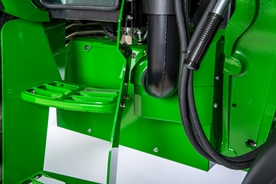 SCR location on the 5M Tractor
SCR location on the 5M Tractor
Exhaust gas recirculation (EGR)
EGR reduces the high temperatures where these compounds are formed in the engine cylinders by replacing excess oxygen with a prescribed amount of cooled exhaust gas.
Exhaust gases contain more carbon dioxide than oxygen. The EGR valve, in conjunction with the venturi tube, and engine control unit (ECU), allow a controlled amount of exhaust gas to enter the intake manifold to mix with the incoming fresh air.
Replacing excess oxygen with cooled exhaust gas leads to:
- Lower combustion temperatures, creating less NOx.
In addition, EGR allows for:
- Advanced timing
- Optimal engine performance
- Maximum fuel economy
For added performance and efficiency, the engine passes the exhaust gases through an EGR cooler before it enters the engine.
Exhaust airflow enters into the EGR cooler from the exhaust manifold near the turbocharger. Based on engine load, air temperatures, and rpm, the ECU opens or closes the EGR valve, allowing a measured percentage of exhaust gas to enter the intake manifold. The gases mix with the rest of the incoming air from the turbocharger and aftercooler before entering the cylinders.
Series turbochargers
The PowerTech™ PWL 4.5L utilizes one turbocharger — a fixed geometry turbocharger. Fresh air is first drawn into the low-pressure fixed geometry turbocharger and compressed to a higher pressure. The compressed air is then routed to the charge air cooler and then to the intake manifold.
Benefits of air-to-air aftercooling
- Lowers the intake manifold air temperature
- Provides more efficient cooling while reducing temperatures for greater engine reliability
- Higher volume of air flows into the cylinders
- Engine is capable of meeting the increasing horsepower demands
Combustion process with externally cooled EGR
Functions:
- According to engine operating conditions, the recirculated exhaust gases reduce the oxygen portion in the intake air to approximately 20 percent. Without any increase of the charge air pressure, the oxygen rate is not high enough to ensure a complete combustion of the fuel injected at high engine loads.
Advantages:
- Fuel-efficient combustion is achieved, because sufficient oxygen is provided.
A restrained, cooler combustion is realized, since the typical hot combustion process, which is generated by an oxygen surplus, is dampened by the inert exhaust gases. Hence, NOx emissions are reduced.
For more information regarding EPA regulations and the technology behind John Deere Integrated Emissions Control systems, please visit the following link:
http://www.deere.com/wps/dcom/en_US/campaigns/ag_turf/emissions/final_tier_4.page
Power bulge and torque reserve pull through the tough spots
5M Final Tier 4 (FT4) engines feature up to a 4 percent power bulge when put under load. The power bulge feature of the electronically controlled engine delivers additional horsepower as engine rpm drops below rated speed. Additionally, a 30 percent torque rise provides the force that maintains horsepower as engine rpm drops below rated speed.
When the tractor is under load, power bulge and torque rise work together to get through the tough spots without having to downshift. Horsepower and torque are mathematically related.
 |
As rpm drops, the only way to maintain or increase horsepower is to provide additional torque. The output horsepower is greater than or equal to rated horsepower as the engine is pulled down to 1750 rpm.
The peak torque rise also occurs near the rated economy power take-off (EPTO) speed.
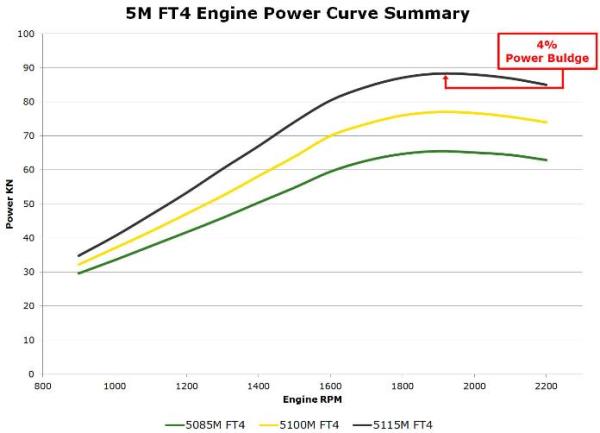 5M power curve summary
5M power curve summary
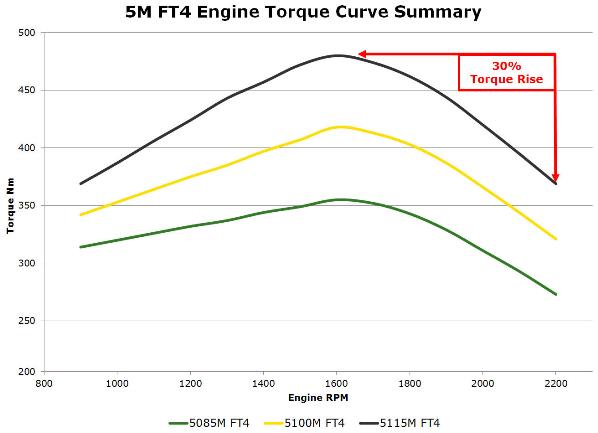 5M torque curve summary
5M torque curve summary
32F/16R PowrReverser™ transmission for ultimate speed control
For operators requiring more field speeds to achieve the most precise operating ranges, as well as for quickly moving from task to task with transport speeds of up to 40.23 km/h (25 mph), the 32F/16R PowrReverser™ Plus transmission is the ideal choice. This transmission provides 32F/16R speeds for the ultimate in speed selection. Convenient push-button controls actuate the electrohydraulic high/low selector.
The forward lever selects one of four speeds, all synchronized shifts for on-the-go shifting with the use of the clutch. This same lever is where the high/low control buttons are located. The rear lever selects ranges A, B, C, or D. Ranges C and D are fully synchronized. That means, when upshifting, operators can move from ranges B to C to D without stopping the tractor. On the downshift, operators can move from D back down to C without stopping.
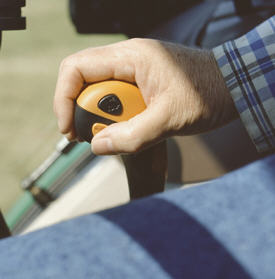 High/Low selector on gear lever
High/Low selector on gear lever

The high/low feature benefits operators who frequently transport their tractors from field to field or find themselves in bog-down situations during rear power take-off (PTO) work. Customers can push the rabbit button (high) without having to depress the clutch to get a 20 percent increase in speed. They can also push the turtle button (low) to get a 20 percent decrease in speed, similar to downshifting or engine braking without having to grab another gear. The 32F/16R transmission includes the infinitely variable shuttle control feature. The PowrReverser™ has a built-in engagement override valve for additional safety. This valve requires the clutch pedal to be depressed one time after each engine start before the transmission will begin to operate normally, giving the operator another opportunity to put all focus on the tractor.
**A neutral start switch requires the directional lever be in the neutral position to start the engine.**
32F/16R transmission includes:
- Wet clutch
- Platform-mounted shift levers (four gears, four ranges, with hi/lo selector)
- Left-hand reverser (F to R without clutching)
- Constant-mesh, helical gears
- Pressure-lubricated top shaft
- Positive park paw
- Neutral start switch
All 5M Tractors have E-PTO (a fuel-saving feature) that allows customers to operate rear implements at 540 PTO rpm but at lower engine rpm. The result is lower engine vibration, reduced noise, less wear and tear on the engine, reduced fuel consumption and increased operator comfort.
**See PTO Functional area for more information on E-PTO**
Heavy-duty 3-point hitch lift capacity for implement versatility
A Category 2, 3-point hitch on 5M Tractors provides the lift capacity and compatibility to perform in a variety of different applications. With the choice of either mechanical or electrohydraulic hitch controls, hooking up implements is convenient with telescoping draft links, adjustable sway bars, and interchangeable hitch balls. Both mechanical and electrohydraulic hitch controls have a depth stop. This feature provides consistency when lowering the hitch. Each time the position control lever is pushed forward, it stops where the depth stop has been positioned. This is valuable to anyone who desires a consistent, level ground, like when preparing a seedbed.
The 3-point hitch adapts to a wide variety of implements and has plenty of lift capacity to handle heavy implements such as planters, sprayers, and field cultivators. The 65-mm (2.5-in.) external cylinders provide for a hitch lift capacity of 2340 kg (5159 lb) at 610-mm (24 in.) behind the hitch-lift balls throughout the lifting range.
 5M 3-point hitch
5M 3-point hitch
5115M Tractors come equipped with one 65-mm (2.5-in.) and one 75 mm (2.9-in), averaging to 70 mm (2.7-in) lift cylinders which provide for 2701 kg (5954 lb) of lift capacity at 610-mm (24-in.) behind the hitch-lift balls, throughout the lifting range. Any 5M Series Tractor has the option of selecting these larger lift cylinders through the factory or a field-installed heavy-duty hitch kit.
Adjustable sway bars and telescoping draft links can be easily adjusted to adapt to a wide variety of implements. The right lift link also adjusts without tools for added convenience when leveling implements. Operators do not need to carry a tool to adjust the rear hitch. Operators can also raise and lower the 3-point hitch from outside of the tractor with the conveniently located rear fender hitch controls.
 5M sway bars
5M sway bars
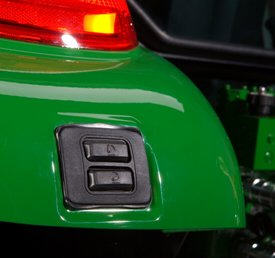 5M rear fender hitch controls
5M rear fender hitch controls
Mid-frame design for support and strength
The exclusive mid-frame design on the 5M Series offers additional strength and durability but also reduces noise and vibration. Because the mid frames are made from hardened cast steel they provide the tractor strength and stability even in the toughest conditions.
The mid frames also support and protect different pieces of essential equipment. The hydraulic pump, located between the mid-frames, is attached to the transmission for short hydraulic lines and simplified fluid flows. An optional mid-mount fuel tank allows the tractor to carry an extra 9 gal. (34L) on cab tractors and an extra 7.8 gal. (29.5L) on OOS tractors. This is especially useful for long days in the field or when a trip to fill up with diesel may not be convenient.
The mid frames are compatible with current loader mounting frames, which is beneficial for those interested in upgrading their tractors and keeping their H-Series Loaders.
Heavy base tractor weight for stability
A heavy tractor means more down force to keep implements in the ground. More weight also leads to improved traction and performance in the field. Because the 5M is made with heavy and durable cast steel, it weighs enough to power through those tough jobs.
The compactness of the 5M Series in regards to wheelbase, weight, and total height tractor makes this tractor suited for a variety of different applications and is the perfect choice for all types of farms.
A heavy tractor also means better stability when performing loader work. Transport full bucket loads faster and lift bales higher with a stronger and more stable base.
 Tractor weight package
Tractor weight package
Model |
5075M* |
5090M |
5100M |
5115M |
| Two-wheel drive (2WD) open operator station (OOS) (lb; kg) |
7400; 3357 | 7300; 3310 | 7500; 3400 | N/A |
| 2WD cab (lb; kg) | 8300; 3765 | 8200; 3720 | 8400; 3810 | N/A |
| Mechanical front-wheel drive (MFWD) OOS (lb; kg) | 7900; 3583 | 7800; 3540 | 8000; 3630 | 8000; 3630 |
| MFWD cab (lb; kg) | 8800; 3992 | 8700; 3950 | 8900; 4040 | 8900; 4040 |
| With H260 mechanical self-leveling (MSL) OOS | ~8307 lb | ~8307 lb | ~8307 lb | ~8307 lb |
| With H260 MSL cab | ~9805 lb | ~9805 lb | ~9805 lb | ~9805 lb |
*FT4 5075M has diesel oxidation catalyst/diesel particulate filter (DOC/DPF)
Premium cab for the ultimate operating experience
The premium cab is designed to provide the ultimate in comfort and convenience. This cab includes all of the features of the standard cab operator station plus much more. Some of the key features include:
- Deluxe sound package with two 4X6 coaxial speakers and subwoofer
- Factory-installed radio
- Bluetooth® ready
- Satellite ready
- USB port
- Auxiliary cord connection
- Additional heating and cooling vents
- Rear windshield wiper and washer
- Loader view window with sun shade
- Rear floor mat
 Key features of the premium cab
Key features of the premium cab
The rear floor mat behind the seat provides additional storage space. To shield the operator from the sun, there is an easy to use front sun shade with a scissor-style design. There is an overhead console with speakers and a map light. The Bluetooth microphone is strategically located for ample sound detection. The rearview mirror is positioned for excellent visibility to rear operations. The premium cab comes with a Bosch® deluxe radio, and offers both an auxiliary and a USB port to charge and connect custom electronic devices. The satellite radio-ready feature makes it easy for customers to convert the sound system to any available service. The sound system includes two 4x6 co-ax speakers in the front of the cab and a subwoofer with amp and crossover.
The loader view window or sun roof has a single handle to open and close and once latched, the sun shade moves with the window.
The auxiliary plug-in as well as the USB connection provide a way to play music through an iPod® or MP3 player.
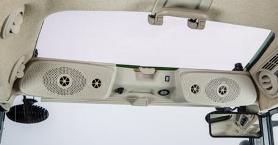 Deluxe sound package and loader window
Deluxe sound package and loader window
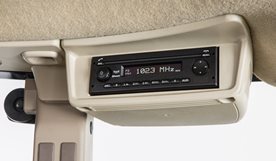 Factory-installed radio
Factory-installed radio
 Rigid front sun shade
Rigid front sun shade
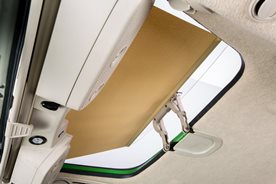 Loader window sun shade and vent
Loader window sun shade and vent
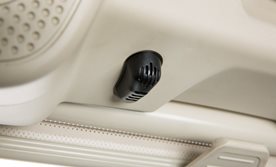 Bluetooth microphone
Bluetooth microphone
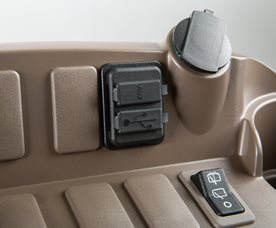 Auxiliary cord connection
Auxiliary cord connection
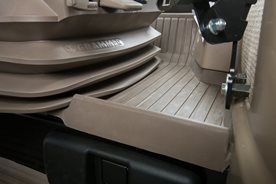 Rear floor mat
Rear floor mat
Bluetooth is a trademark of Bluetooth SIG Incorporated. iPod is a trademark of Apple Inc. Bosch is a trademark of Robert Bosch GmbH.
Speakers and subwoofer create powerful sound
5M premium cabs now include a subwoofer and two 4X6 co-axial speakers for premium sound quality and music delivery.
 Speakers
Speakers
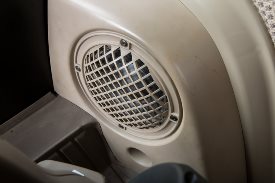 Subwoofer
Subwoofer
Automotive-style light-emitting diode (LED) instrument cluster
Controlling the 5M is easier and brighter than ever before. A fresh new instrument cluster displays information in a crisp, vibrant, and useful array. A larger alternator (OOS: 90 amp, cab: 120 amp) produces plenty of power for internal and external components.
This window into tractor functionality and diagnostics provides ample information. Indicators, warning lights, and even the gauges are clear and bright. The roll-mode function now provides operators with crucial onboard diagnostics. Engine hours, PTO speed, ground speed, hi-lo indicator, forward, neutral, and reverse, are all visible at the same time. There is a light-out indicator for trailer light, turn light, and hazard light bulbs which is driven by new software. A straightforward layout and sleek design requires no customer interface. When operating the PTO, there are clearly presented PTO target bars to indicate the correct PTO speed.
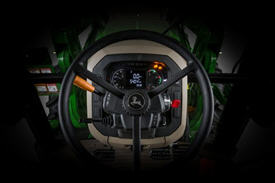 Instrument cluster - cab
Instrument cluster - cab
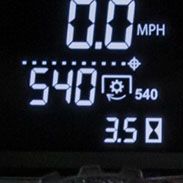 PTO target bars
PTO target bars
There are daytime and nighttime modes which are based on the position of the light switch. The mode actually adjusts the backlight levels of the display for optimum visibility.
AutoTrac™ Universal
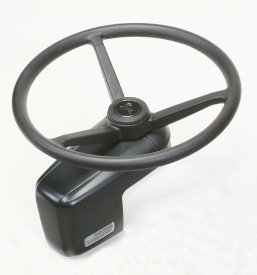
The AutoTrac™ Universal (ATU) 200 steering kit is a machine steering kit used for automatic guidance in John Deere and non-John Deere machines. Pair the machine kit with a complete GreenStar™ system to operate automatic, hands-free guidance in approved machine platforms.
AutoTrac offers many benefits to operators, including optimized machine efficiency, reduced operator fatigue, and the ability to work at faster speeds. The ATU 200 is the premier universal steering system in the agricultural industry.
Gain accuracy, up to +/- 2.5 cm (1 in.) pass to pass with a StarFire™ 3000 Receiver
Increase profitability and reduce overlap
Reduce operator fatigue and time spent in each field
Features
EPA Final Tier 4 (FT4) compliant engines with maximum fluid efficiency
The U.S. Environmental Protection Agency and Environment Canada requires all off-road diesel engines with 25 hp or more to meet stringent FT4 emissions regulations. John Deere uses the most efficient and cost-effective solution for the tractor package to meet emissions requirements at each horsepower level. The 5M delivers a hassle-free emissions solution that allows faster work and operation with ease.
The engine powering the 5M is EPA certified Tier Level 4. This is achieved through a combination of a diesel oxidation catalyst (DOC) and selective catalytic reduction (SCR) using diesel exhaust fluid (DEF, or urea).
Several defining features on the 5M maximize the performance and reliability of the emissions package. A completely shielded DOC/SCR not only protects essential components from damage, it also keeps out dirt and debris. The well-packaged and tightly organized circulation system means there is more room to work around the tractor.
 PowerTech PWL Final Tier 4 technology
PowerTech PWL Final Tier 4 technology
Key components of the emissions system include:
DOC
John Deere has chosen to utilize an exhaust filter to reduce particulate material so the engine can operate at a level which produces less NOx. With less NOx created, less DEF is required to treat. The result is improved total fluid economy (diesel and DEF).
The engine is programmed to aggressively respond to changes in power needs, which can temporarily increase particulate matter. Since the exhaust filter removes particulate matter instead of the engine, the engine is left free to do what it is designed to do – deliver all of the power, torque, plus transient response needed.
DEF
DEF is an ISO 22241 standard aqueous urea solution consisting of 32.5 percent urea and has a freezing point of -11°C (12°F). A heated DEF tank keeps the customer in the field longer even when the temperatures drop below freezing. The DEF tank header is integrated with a temperature sensor, and plumbed engine coolant lines are used to promote thawing and prevent freezing in the tank during operation.
 DEF tank
DEF tank
Mounted near the DEF tank, the electronic control unit (ECU)-controlled supply module draws diesel exhaust fluid from the storage tank and provides a pressurized flow to the dosing module. When the ignition key is off, the supply module pump will reverse direction to return any accumulated fluid back to the tank. The supply module is also fitted with a replaceable filter to prevent contaminants from entering the dosing lines. Both the supply module and dosing lines are electrically heated and controlled by the ECU to determine when DEF dosing can begin.
The dosing module is cooled by engine coolant and used to inject DEF at a pressure of 130 psi (900 kPa, 9 bar) into the decomposition tube. A harness is connected to the dosing valve that relays the needed DEF to inject based upon the amount of NOx exiting the DOC measured from the NOx tube sensor.
The decomposition tube is the internal mixing device used to circulate DEF with engine exhaust prior to entering the SCR/AOC after-treatment device.
SCR
To reduce the NOx, DEF is injected into the exhaust stream. When the exhaust gases combine with the DEF in the SCR catalyst, the NOx is broken down into nitrogen and water vapor.
 SCR location on the 5M Tractor
SCR location on the 5M Tractor
Exhaust gas recirculation (EGR)
EGR reduces the high temperatures where these compounds are formed in the engine cylinders by replacing excess oxygen with a prescribed amount of cooled exhaust gas.
Exhaust gases contain more carbon dioxide than oxygen. The EGR valve, in conjunction with the venturi tube, and engine control unit (ECU), allow a controlled amount of exhaust gas to enter the intake manifold to mix with the incoming fresh air.
Replacing excess oxygen with cooled exhaust gas leads to:
- Lower combustion temperatures, creating less NOx.
In addition, EGR allows for:
- Advanced timing
- Optimal engine performance
- Maximum fuel economy
For added performance and efficiency, the engine passes the exhaust gases through an EGR cooler before it enters the engine.
Exhaust airflow enters into the EGR cooler from the exhaust manifold near the turbocharger. Based on engine load, air temperatures, and rpm, the ECU opens or closes the EGR valve, allowing a measured percentage of exhaust gas to enter the intake manifold. The gases mix with the rest of the incoming air from the turbocharger and aftercooler before entering the cylinders.
Series turbochargers
The PowerTech™ PWL 4.5L utilizes one turbocharger — a fixed geometry turbocharger. Fresh air is first drawn into the low-pressure fixed geometry turbocharger and compressed to a higher pressure. The compressed air is then routed to the charge air cooler and then to the intake manifold.
Benefits of air-to-air aftercooling
- Lowers the intake manifold air temperature
- Provides more efficient cooling while reducing temperatures for greater engine reliability
- Higher volume of air flows into the cylinders
- Engine is capable of meeting the increasing horsepower demands
Combustion process with externally cooled EGR
Functions:
- According to engine operating conditions, the recirculated exhaust gases reduce the oxygen portion in the intake air to approximately 20 percent. Without any increase of the charge air pressure, the oxygen rate is not high enough to ensure a complete combustion of the fuel injected at high engine loads.
Advantages:
- Fuel-efficient combustion is achieved, because sufficient oxygen is provided.
A restrained, cooler combustion is realized, since the typical hot combustion process, which is generated by an oxygen surplus, is dampened by the inert exhaust gases. Hence, NOx emissions are reduced.
For more information regarding EPA regulations and the technology behind John Deere Integrated Emissions Control systems, please visit the following link:
http://www.deere.com/wps/dcom/en_US/campaigns/ag_turf/emissions/final_tier_4.page
Power bulge and torque reserve pull through the tough spots
5M Final Tier 4 (FT4) engines feature up to a 4 percent power bulge when put under load. The power bulge feature of the electronically controlled engine delivers additional horsepower as engine rpm drops below rated speed. Additionally, a 30 percent torque rise provides the force that maintains horsepower as engine rpm drops below rated speed.
When the tractor is under load, power bulge and torque rise work together to get through the tough spots without having to downshift. Horsepower and torque are mathematically related.
 |
As rpm drops, the only way to maintain or increase horsepower is to provide additional torque. The output horsepower is greater than or equal to rated horsepower as the engine is pulled down to 1750 rpm.
The peak torque rise also occurs near the rated economy power take-off (EPTO) speed.
 5M power curve summary
5M power curve summary
 5M torque curve summary
5M torque curve summary
32F/16R PowrReverser™ transmission for ultimate speed control
For operators requiring more field speeds to achieve the most precise operating ranges, as well as for quickly moving from task to task with transport speeds of up to 40.23 km/h (25 mph), the 32F/16R PowrReverser™ Plus transmission is the ideal choice. This transmission provides 32F/16R speeds for the ultimate in speed selection. Convenient push-button controls actuate the electrohydraulic high/low selector.
The forward lever selects one of four speeds, all synchronized shifts for on-the-go shifting with the use of the clutch. This same lever is where the high/low control buttons are located. The rear lever selects ranges A, B, C, or D. Ranges C and D are fully synchronized. That means, when upshifting, operators can move from ranges B to C to D without stopping the tractor. On the downshift, operators can move from D back down to C without stopping.
 High/Low selector on gear lever
High/Low selector on gear lever

The high/low feature benefits operators who frequently transport their tractors from field to field or find themselves in bog-down situations during rear power take-off (PTO) work. Customers can push the rabbit button (high) without having to depress the clutch to get a 20 percent increase in speed. They can also push the turtle button (low) to get a 20 percent decrease in speed, similar to downshifting or engine braking without having to grab another gear. The 32F/16R transmission includes the infinitely variable shuttle control feature. The PowrReverser™ has a built-in engagement override valve for additional safety. This valve requires the clutch pedal to be depressed one time after each engine start before the transmission will begin to operate normally, giving the operator another opportunity to put all focus on the tractor.
**A neutral start switch requires the directional lever be in the neutral position to start the engine.**
32F/16R transmission includes:
- Wet clutch
- Platform-mounted shift levers (four gears, four ranges, with hi/lo selector)
- Left-hand reverser (F to R without clutching)
- Constant-mesh, helical gears
- Pressure-lubricated top shaft
- Positive park paw
- Neutral start switch
All 5M Tractors have E-PTO (a fuel-saving feature) that allows customers to operate rear implements at 540 PTO rpm but at lower engine rpm. The result is lower engine vibration, reduced noise, less wear and tear on the engine, reduced fuel consumption and increased operator comfort.
**See PTO Functional area for more information on E-PTO**
Heavy-duty 3-point hitch lift capacity for implement versatility
A Category 2, 3-point hitch on 5M Tractors provides the lift capacity and compatibility to perform in a variety of different applications. With the choice of either mechanical or electrohydraulic hitch controls, hooking up implements is convenient with telescoping draft links, adjustable sway bars, and interchangeable hitch balls. Both mechanical and electrohydraulic hitch controls have a depth stop. This feature provides consistency when lowering the hitch. Each time the position control lever is pushed forward, it stops where the depth stop has been positioned. This is valuable to anyone who desires a consistent, level ground, like when preparing a seedbed.
The 3-point hitch adapts to a wide variety of implements and has plenty of lift capacity to handle heavy implements such as planters, sprayers, and field cultivators. The 65-mm (2.5-in.) external cylinders provide for a hitch lift capacity of 2340 kg (5159 lb) at 610-mm (24 in.) behind the hitch-lift balls throughout the lifting range.
 5M 3-point hitch
5M 3-point hitch
5115M Tractors come equipped with one 65-mm (2.5-in.) and one 75 mm (2.9-in), averaging to 70 mm (2.7-in) lift cylinders which provide for 2701 kg (5954 lb) of lift capacity at 610-mm (24-in.) behind the hitch-lift balls, throughout the lifting range. Any 5M Series Tractor has the option of selecting these larger lift cylinders through the factory or a field-installed heavy-duty hitch kit.
Adjustable sway bars and telescoping draft links can be easily adjusted to adapt to a wide variety of implements. The right lift link also adjusts without tools for added convenience when leveling implements. Operators do not need to carry a tool to adjust the rear hitch. Operators can also raise and lower the 3-point hitch from outside of the tractor with the conveniently located rear fender hitch controls.
 5M sway bars
5M sway bars
 5M rear fender hitch controls
5M rear fender hitch controls
Mid-frame design for support and strength
The exclusive mid-frame design on the 5M Series offers additional strength and durability but also reduces noise and vibration. Because the mid frames are made from hardened cast steel they provide the tractor strength and stability even in the toughest conditions.
The mid frames also support and protect different pieces of essential equipment. The hydraulic pump, located between the mid-frames, is attached to the transmission for short hydraulic lines and simplified fluid flows. An optional mid-mount fuel tank allows the tractor to carry an extra 9 gal. (34L) on cab tractors and an extra 7.8 gal. (29.5L) on OOS tractors. This is especially useful for long days in the field or when a trip to fill up with diesel may not be convenient.
The mid frames are compatible with current loader mounting frames, which is beneficial for those interested in upgrading their tractors and keeping their H-Series Loaders.
Heavy base tractor weight for stability
A heavy tractor means more down force to keep implements in the ground. More weight also leads to improved traction and performance in the field. Because the 5M is made with heavy and durable cast steel, it weighs enough to power through those tough jobs.
The compactness of the 5M Series in regards to wheelbase, weight, and total height tractor makes this tractor suited for a variety of different applications and is the perfect choice for all types of farms.
A heavy tractor also means better stability when performing loader work. Transport full bucket loads faster and lift bales higher with a stronger and more stable base.
 Tractor weight package
Tractor weight package
Model |
5075M* |
5090M |
5100M |
5115M |
| Two-wheel drive (2WD) open operator station (OOS) (lb; kg) |
7400; 3357 | 7300; 3310 | 7500; 3400 | N/A |
| 2WD cab (lb; kg) | 8300; 3765 | 8200; 3720 | 8400; 3810 | N/A |
| Mechanical front-wheel drive (MFWD) OOS (lb; kg) | 7900; 3583 | 7800; 3540 | 8000; 3630 | 8000; 3630 |
| MFWD cab (lb; kg) | 8800; 3992 | 8700; 3950 | 8900; 4040 | 8900; 4040 |
| With H260 mechanical self-leveling (MSL) OOS | ~8307 lb | ~8307 lb | ~8307 lb | ~8307 lb |
| With H260 MSL cab | ~9805 lb | ~9805 lb | ~9805 lb | ~9805 lb |
*FT4 5075M has diesel oxidation catalyst/diesel particulate filter (DOC/DPF)
Premium cab for the ultimate operating experience
The premium cab is designed to provide the ultimate in comfort and convenience. This cab includes all of the features of the standard cab operator station plus much more. Some of the key features include:
- Deluxe sound package with two 4X6 coaxial speakers and subwoofer
- Factory-installed radio
- Bluetooth® ready
- Satellite ready
- USB port
- Auxiliary cord connection
- Additional heating and cooling vents
- Rear windshield wiper and washer
- Loader view window with sun shade
- Rear floor mat
 Key features of the premium cab
Key features of the premium cab
The rear floor mat behind the seat provides additional storage space. To shield the operator from the sun, there is an easy to use front sun shade with a scissor-style design. There is an overhead console with speakers and a map light. The Bluetooth microphone is strategically located for ample sound detection. The rearview mirror is positioned for excellent visibility to rear operations. The premium cab comes with a Bosch® deluxe radio, and offers both an auxiliary and a USB port to charge and connect custom electronic devices. The satellite radio-ready feature makes it easy for customers to convert the sound system to any available service. The sound system includes two 4x6 co-ax speakers in the front of the cab and a subwoofer with amp and crossover.
The loader view window or sun roof has a single handle to open and close and once latched, the sun shade moves with the window.
The auxiliary plug-in as well as the USB connection provide a way to play music through an iPod® or MP3 player.
 Deluxe sound package and loader window
Deluxe sound package and loader window
 Factory-installed radio
Factory-installed radio
 Rigid front sun shade
Rigid front sun shade
 Loader window sun shade and vent
Loader window sun shade and vent
 Bluetooth microphone
Bluetooth microphone
 Auxiliary cord connection
Auxiliary cord connection
 Rear floor mat
Rear floor mat
Bluetooth is a trademark of Bluetooth SIG Incorporated. iPod is a trademark of Apple Inc. Bosch is a trademark of Robert Bosch GmbH.
Speakers and subwoofer create powerful sound
5M premium cabs now include a subwoofer and two 4X6 co-axial speakers for premium sound quality and music delivery.
 Speakers
Speakers
 Subwoofer
Subwoofer
Automotive-style light-emitting diode (LED) instrument cluster
Controlling the 5M is easier and brighter than ever before. A fresh new instrument cluster displays information in a crisp, vibrant, and useful array. A larger alternator (OOS: 90 amp, cab: 120 amp) produces plenty of power for internal and external components.
This window into tractor functionality and diagnostics provides ample information. Indicators, warning lights, and even the gauges are clear and bright. The roll-mode function now provides operators with crucial onboard diagnostics. Engine hours, PTO speed, ground speed, hi-lo indicator, forward, neutral, and reverse, are all visible at the same time. There is a light-out indicator for trailer light, turn light, and hazard light bulbs which is driven by new software. A straightforward layout and sleek design requires no customer interface. When operating the PTO, there are clearly presented PTO target bars to indicate the correct PTO speed.
 Instrument cluster - cab
Instrument cluster - cab
 PTO target bars
PTO target bars
There are daytime and nighttime modes which are based on the position of the light switch. The mode actually adjusts the backlight levels of the display for optimum visibility.
AutoTrac™ Universal

The AutoTrac™ Universal (ATU) 200 steering kit is a machine steering kit used for automatic guidance in John Deere and non-John Deere machines. Pair the machine kit with a complete GreenStar™ system to operate automatic, hands-free guidance in approved machine platforms.
AutoTrac offers many benefits to operators, including optimized machine efficiency, reduced operator fatigue, and the ability to work at faster speeds. The ATU 200 is the premier universal steering system in the agricultural industry.
Gain accuracy, up to +/- 2.5 cm (1 in.) pass to pass with a StarFire™ 3000 Receiver
Increase profitability and reduce overlap
Reduce operator fatigue and time spent in each field
Features
EPA Final Tier 4 (FT4) compliant engines with maximum fluid efficiency
The U.S. Environmental Protection Agency and Environment Canada requires all off-road diesel engines with 25 hp or more to meet stringent FT4 emissions regulations. John Deere uses the most efficient and cost-effective solution for the tractor package to meet emissions requirements at each horsepower level. The 5M delivers a hassle-free emissions solution that allows faster work and operation with ease.
The engine powering the 5M is EPA certified Tier Level 4. This is achieved through a combination of a diesel oxidation catalyst (DOC) and selective catalytic reduction (SCR) using diesel exhaust fluid (DEF, or urea).
Several defining features on the 5M maximize the performance and reliability of the emissions package. A completely shielded DOC/SCR not only protects essential components from damage, it also keeps out dirt and debris. The well-packaged and tightly organized circulation system means there is more room to work around the tractor.
 PowerTech PWL Final Tier 4 technology
PowerTech PWL Final Tier 4 technology
Key components of the emissions system include:
DOC
John Deere has chosen to utilize an exhaust filter to reduce particulate material so the engine can operate at a level which produces less NOx. With less NOx created, less DEF is required to treat. The result is improved total fluid economy (diesel and DEF).
The engine is programmed to aggressively respond to changes in power needs, which can temporarily increase particulate matter. Since the exhaust filter removes particulate matter instead of the engine, the engine is left free to do what it is designed to do – deliver all of the power, torque, plus transient response needed.
DEF
DEF is an ISO 22241 standard aqueous urea solution consisting of 32.5 percent urea and has a freezing point of -11°C (12°F). A heated DEF tank keeps the customer in the field longer even when the temperatures drop below freezing. The DEF tank header is integrated with a temperature sensor, and plumbed engine coolant lines are used to promote thawing and prevent freezing in the tank during operation.
 DEF tank
DEF tank
Mounted near the DEF tank, the electronic control unit (ECU)-controlled supply module draws diesel exhaust fluid from the storage tank and provides a pressurized flow to the dosing module. When the ignition key is off, the supply module pump will reverse direction to return any accumulated fluid back to the tank. The supply module is also fitted with a replaceable filter to prevent contaminants from entering the dosing lines. Both the supply module and dosing lines are electrically heated and controlled by the ECU to determine when DEF dosing can begin.
The dosing module is cooled by engine coolant and used to inject DEF at a pressure of 130 psi (900 kPa, 9 bar) into the decomposition tube. A harness is connected to the dosing valve that relays the needed DEF to inject based upon the amount of NOx exiting the DOC measured from the NOx tube sensor.
The decomposition tube is the internal mixing device used to circulate DEF with engine exhaust prior to entering the SCR/AOC after-treatment device.
SCR
To reduce the NOx, DEF is injected into the exhaust stream. When the exhaust gases combine with the DEF in the SCR catalyst, the NOx is broken down into nitrogen and water vapor.
 SCR location on the 5M Tractor
SCR location on the 5M Tractor
Exhaust gas recirculation (EGR)
EGR reduces the high temperatures where these compounds are formed in the engine cylinders by replacing excess oxygen with a prescribed amount of cooled exhaust gas.
Exhaust gases contain more carbon dioxide than oxygen. The EGR valve, in conjunction with the venturi tube, and engine control unit (ECU), allow a controlled amount of exhaust gas to enter the intake manifold to mix with the incoming fresh air.
Replacing excess oxygen with cooled exhaust gas leads to:
- Lower combustion temperatures, creating less NOx.
In addition, EGR allows for:
- Advanced timing
- Optimal engine performance
- Maximum fuel economy
For added performance and efficiency, the engine passes the exhaust gases through an EGR cooler before it enters the engine.
Exhaust airflow enters into the EGR cooler from the exhaust manifold near the turbocharger. Based on engine load, air temperatures, and rpm, the ECU opens or closes the EGR valve, allowing a measured percentage of exhaust gas to enter the intake manifold. The gases mix with the rest of the incoming air from the turbocharger and aftercooler before entering the cylinders.
Series turbochargers
The PowerTech™ PWL 4.5L utilizes one turbocharger — a fixed geometry turbocharger. Fresh air is first drawn into the low-pressure fixed geometry turbocharger and compressed to a higher pressure. The compressed air is then routed to the charge air cooler and then to the intake manifold.
Benefits of air-to-air aftercooling
- Lowers the intake manifold air temperature
- Provides more efficient cooling while reducing temperatures for greater engine reliability
- Higher volume of air flows into the cylinders
- Engine is capable of meeting the increasing horsepower demands
Combustion process with externally cooled EGR
Functions:
- According to engine operating conditions, the recirculated exhaust gases reduce the oxygen portion in the intake air to approximately 20 percent. Without any increase of the charge air pressure, the oxygen rate is not high enough to ensure a complete combustion of the fuel injected at high engine loads.
Advantages:
- Fuel-efficient combustion is achieved, because sufficient oxygen is provided.
A restrained, cooler combustion is realized, since the typical hot combustion process, which is generated by an oxygen surplus, is dampened by the inert exhaust gases. Hence, NOx emissions are reduced.
For more information regarding EPA regulations and the technology behind John Deere Integrated Emissions Control systems, please visit the following link:
http://www.deere.com/wps/dcom/en_US/campaigns/ag_turf/emissions/final_tier_4.page
Power bulge and torque reserve pull through the tough spots
5M Final Tier 4 (FT4) engines feature up to a 4 percent power bulge when put under load. The power bulge feature of the electronically controlled engine delivers additional horsepower as engine rpm drops below rated speed. Additionally, a 30 percent torque rise provides the force that maintains horsepower as engine rpm drops below rated speed.
When the tractor is under load, power bulge and torque rise work together to get through the tough spots without having to downshift. Horsepower and torque are mathematically related.
 |
As rpm drops, the only way to maintain or increase horsepower is to provide additional torque. The output horsepower is greater than or equal to rated horsepower as the engine is pulled down to 1750 rpm.
The peak torque rise also occurs near the rated economy power take-off (EPTO) speed.
 5M power curve summary
5M power curve summary
 5M torque curve summary
5M torque curve summary
32F/16R PowrReverser™ transmission for ultimate speed control
For operators requiring more field speeds to achieve the most precise operating ranges, as well as for quickly moving from task to task with transport speeds of up to 40.23 km/h (25 mph), the 32F/16R PowrReverser™ Plus transmission is the ideal choice. This transmission provides 32F/16R speeds for the ultimate in speed selection. Convenient push-button controls actuate the electrohydraulic high/low selector. Also incorporated into the gear-shift lever is the declutch button. No foot clutching required to shift between gears within a range.
The forward lever selects one of four speeds, all synchronized shifts for on-the-go shifting with the use of the clutch. This same lever is where the high/low and declutch control buttons are located. The rear lever selects ranges A, B, C, or D. Ranges C and D are fully synchronized. That means, when upshifting, operators can move from ranges B to C to D without stopping the tractor. On the downshift, operators can move from D back down to C without stopping.
 High/Low selector on gear lever
High/Low selector on gear lever
The high/low feature benefits operators who frequently transport their tractors from field to field or find themselves in bog-down situations during rear power take-off (PTO) work. Customers can push the rabbit button (high) without having to depress the clutch to get a 20 percent increase in speed. They can also push the turtle button (low) to get a 20 percent decrease in speed, similar to downshifting or engine braking without having to grab another gear. The 32F/16R transmission includes the infinitely variable shuttle control feature. The PowrReverser™ has a built-in engagement override valve for additional safety. This valve requires the clutch pedal to be depressed one time after each engine start before the transmission will begin to operate normally, giving the operator another opportunity to put all focus on the tractor.
**A neutral start switch requires the directional lever be in the neutral position to start the engine.**
32F/16R transmission includes:
- Wet clutch
- Platform-mounted shift levers (four gears, four ranges, with hi/lo selector)
- Declutch button integrated into gear-shift lever
- Left-hand reverser (F to R without clutching)
- Constant-mesh, helical gears
- Pressure-lubricated top shaft
- Positive park paw
- Neutral start switch
All 5M Tractors have E-PTO (a fuel-saving feature) that allows customers to operate rear implements at 540 PTO rpm but at lower engine rpm. The result is lower engine vibration, reduced noise, less wear and tear on the engine, reduced fuel consumption and increased operator comfort.
**See PTO Functional area for more information on E-PTO**
Heavy-duty 3-point hitch lift capacity for implement versatility
A Category 2, 3-point hitch on 5M Tractors provides the lift capacity and compatibility to perform in a variety of different applications. With the choice of either mechanical or electrohydraulic hitch controls, hooking up implements is convenient with telescoping draft links, adjustable sway bars, and interchangeable hitch balls. Both mechanical and electrohydraulic hitch controls have a depth stop. This feature provides consistency when lowering the hitch. Each time the position control lever is pushed forward, it stops where the depth stop has been positioned. This is valuable to anyone who desires a consistent, level ground, like when preparing a seedbed.
The 3-point hitch adapts to a wide variety of implements and has plenty of lift capacity to handle heavy implements such as planters, sprayers, and field cultivators. The 65 -mm (2.5-in.) external cylinders provide for a hitch lift capacity of 2340 kg (5159 lb) at 610-mm (24 in.) behind the hitch-lift balls throughout the lifting range.
 5M 3-point hitch
5M 3-point hitch
5115M Tractors come equipped with one 65-mm (2.5-in.) and one 75 mm (2.9-in), averaging to 70 mm (2.7-in) lift cylinders which provide for 2701 kg (5954 lb) of lift capacity at 610-mm (24-in.) behind the hitch-lift balls, throughout the lifting range. Any 5M Series Tractor has the option of selecting these larger lift cylinders through the factory or a field-installed heavy-duty hitch kit.
Adjustable sway bars and telescoping draft links can be easily adjusted to adapt to a wide variety of implements. The right lift link also adjusts without tools for added convenience when leveling implements. Operators do not need to carry a tool to adjust the rear hitch. Operators can also raise and lower the 3-point hitch from outside of the tractor with the conveniently located rear fender hitch controls.
 5M sway bars
5M sway bars
 5M rear fender hitch controls
5M rear fender hitch controls
Mid-frame design for support and strength
The exclusive mid-frame design on the 5M Series offers additional strength and durability but also reduces noise and vibration. Because the mid frames are made from hardened cast steel they provide the tractor strength and stability even in the toughest conditions.
The mid frames also support and protect different pieces of essential equipment. The hydraulic pump, located between the mid-frames, is attached to the transmission for short hydraulic lines and simplified fluid flows. An optional mid-mount fuel tank allows the tractor to carry an extra 9 gal. (34L) on cab tractors and an extra 7.8 gal. (29.5L) on OOS tractors. This is especially useful for long days in the field or when a trip to fill up with diesel may not be convenient.
Engine side frames
The engine side frames have been updated on the 5M Tractors that increases the maximum steering angle to 50 degrees, and shortens turning radius from 4.8 m to 4.2 m, (15.75 ft to 13.77 ft).
The mid frames are compatible with current loader mounting frames, which is beneficial for those interested in upgrading their tractors and keeping their H-Series Loaders.
Heavy base tractor weight for stability
A heavy tractor means more down force to keep implements in the ground. More weight also leads to improved traction and performance in the field. Because the 5M is made with heavy and durable cast steel, it weighs enough to power through those tough jobs.
The compactness of the 5M Series in regards to wheelbase, weight, and total height tractor makes this tractor suited for a variety of different applications and is the perfect choice for all types of farms.
A heavy tractor also means better stability when performing loader work. Transport full bucket loads faster and lift bales higher with a stronger and more stable base.
 Tractor weight package
Tractor weight package
Model |
5075M* |
5090M |
5100M |
5115M |
| Two-wheel drive (2WD) open operator station (OOS) (lb; kg) |
7400; 3357 | 7300; 3310 | 7500; 3400 | N/A |
| 2WD cab (lb; kg) | 8300; 3765 | 8200; 3720 | 8400; 3810 | N/A |
| Mechanical front-wheel drive (MFWD) OOS (lb; kg) | 7900; 3583 | 7800; 3540 | 8000; 3630 | 8000; 3630 |
| MFWD cab (lb; kg) | 8800; 3992 | 8700; 3950 | 8900; 4040 | 8900; 4040 |
| With H260 mechanical self-leveling (MSL) OOS | ~8307 lb | ~8307 lb | ~8307 lb | ~8307 lb |
| With H260 MSL cab | ~9805 lb | ~9805 lb | ~9805 lb | ~9805 lb |
*FT4 5075M has diesel oxidation catalyst/diesel particulate filter (DOC/DPF)
Premium cab for the ultimate operating experience
The premium cab is designed to provide the ultimate in comfort and convenience. This cab includes all of the features of the standard cab operator station plus much more. Some of the key features include:
- Deluxe sound package with two 4X6 coaxial speakers and subwoofer
- Factory-installed radio
- Bluetooth® ready
- Satellite ready
- USB port
- Auxiliary cord connection
- Additional heating and cooling vents
- Rear windshield wiper and washer
- Loader view window with sun shade
- Rear floor mat
 Key features of the premium cab
Key features of the premium cab
The rear floor mat behind the seat provides additional storage space. To shield the operator from the sun, there is an easy to use front sun shade with a scissor-style design. There is an overhead console with speakers and a map light. The Bluetooth microphone is strategically located for ample sound detection. The rearview mirror is positioned for excellent visibility to rear operations. The premium cab comes with a Bosch® deluxe radio, and offers both an auxiliary and a USB port to charge and connect custom electronic devices. The satellite radio-ready feature makes it easy for customers to convert the sound system to any available service. The sound system includes two 4x6 co-ax speakers in the front of the cab and a subwoofer with amp and crossover.
The loader view window or sun roof has a single handle to open and close and once latched, the sun shade moves with the window.
The auxiliary plug-in as well as the USB connection provide a way to play music through an iPod® or MP3 player.
 Deluxe sound package and loader window
Deluxe sound package and loader window
 Factory-installed radio
Factory-installed radio
 Rigid front sun shade
Rigid front sun shade
 Loader window sun shade and vent
Loader window sun shade and vent
 Bluetooth microphone
Bluetooth microphone
 Auxiliary cord connection
Auxiliary cord connection
 Rear floor mat
Rear floor mat
Bluetooth is a trademark of Bluetooth SIG Incorporated. iPod is a trademark of Apple Inc. Bosch is a trademark of Robert Bosch GmbH.
Speakers and subwoofer create powerful sound
5M premium cabs now include a subwoofer and two 4X6 co-axial speakers for premium sound quality and music delivery.
 Speakers
Speakers
 Subwoofer
Subwoofer
Automotive-style light-emitting diode (LED) instrument cluster
Controlling the 5M is easier and brighter than ever before. A fresh new instrument cluster displays information in a crisp, vibrant, and useful array. A larger alternator (OOS: 90 amp, cab: 120 amp) produces plenty of power for internal and external components.
This window into tractor functionality and diagnostics provides ample information. Indicators, warning lights, and even the gauges are clear and bright. The roll-mode function now provides operators with crucial onboard diagnostics. Engine hours, PTO speed, ground speed, hi-lo indicator, forward, neutral, and reverse, are all visible at the same time. There is a light-out indicator for trailer light, turn light, and hazard light bulbs which is driven by new software. A straightforward layout and sleek design requires no customer interface. When operating the PTO, there are clearly presented PTO target bars to indicate the correct PTO speed.
 Instrument cluster - cab
Instrument cluster - cab
 PTO target bars
PTO target bars
There are daytime and nighttime modes which are based on the position of the light switch. The mode actually adjusts the backlight levels of the display for optimum visibility.
AutoTrac™ Universal

The AutoTrac™ Universal (ATU) 200 steering kit is a machine steering kit used for automatic guidance in John Deere and non-John Deere machines. Pair the machine kit with a complete GreenStar™ system to operate automatic, hands-free guidance in approved machine platforms.
AutoTrac offers many benefits to operators, including optimized machine efficiency, reduced operator fatigue, and the ability to work at faster speeds. The ATU 200 is the premier universal steering system in the agricultural industry.
Gain accuracy, up to +/- 2.5 cm (1 in.) pass to pass with a StarFire™ 3000 Receiver
Increase profitability and reduce overlap
Reduce operator fatigue and time spent in each field
Features
AutoTrac™ Universal

The AutoTrac™ Universal (ATU) 200 steering kit is a machine steering kit used for automatic guidance in John Deere and non-John Deere machines. Pair the machine kit with a complete GreenStar™ system to operate automatic, hands-free guidance in approved machine platforms.
AutoTrac offers many benefits to operators, including optimized machine efficiency, reduced operator fatigue, and the ability to work at faster speeds. The ATU 200 is the premier universal steering system in the agricultural industry.
Gain accuracy, up to +/- 2.5 cm (1 in.) pass to pass with a StarFire™ 3000 Receiver
Increase profitability and reduce overlap
Reduce operator fatigue and time spent in each field
Heavy base tractor weight for stability
A heavy tractor means more down force to keep implements in the ground. More weight also leads to improved traction and performance in the field. Because the 5M is made with heavy and durable cast steel, it weighs enough to power through those tough jobs.
The compactness of the 5M Series in regards to wheelbase, weight, and total height tractor makes this tractor suited for a variety of different applications and is the perfect choice for all types of farms.
A heavy tractor also means better stability when performing loader work. Transport full bucket loads faster and lift bales higher with a stronger and more stable base.
 Tractor weight package
Tractor weight package

Model |
5075M* |
5085M |
5100M |
5115M |
| Two-wheel drive (2WD) open operator station (OOS) (lb; kg) |
7400; 3357 | 7300; 3310 | 7500; 3400 | N/A |
| 2WD cab (lb; kg) | 8300; 3765 | 8200; 3720 | 8400; 3810 | N/A |
| Mechanical front-wheel drive (MFWD) OOS (lb; kg) | 7900; 3583 | 7800; 3540 | 8000; 3630 | 8000; 3630 |
| MFWD cab (lb; kg) | 8800; 3992 | 8700; 3950 | 8900; 4040 | 8900; 4040 |
| With H260 mechanical self-leveling (MSL) OOS | ~8307 lb | ~8307 lb | ~8307 lb | ~8307 lb |
| With H260 MSL cab | ~9805 lb | ~9805 lb | ~9805 lb | ~9805 lb |
*FT4 5075M has diesel oxidation catalyst/diesel particulate filter (DOC/DPF)
Mid-frame design for support and strength
The exclusive mid-frame design on the 5M Series offers additional strength and durability but also reduces noise and vibration. Because the mid frames are made from hardened cast steel they provide the tractor strength and stability even in the toughest conditions.
The mid frames also support and protect different pieces of essential equipment. The hydraulic pump, located between the mid-frames, is attached to the transmission for short hydraulic lines and simplified fluid flows. An optional mid-mount fuel tank allows the tractor to carry an extra 9 gal. (34L) on cab tractors and an extra 7.8 gal. (29.5L) on OOS tractors. This is especially useful for long days in the field or when a trip to fill up with diesel may not be convenient.
The mid frames are compatible with current loader mounting frames, which is beneficial for those interested in upgrading their tractors and keeping their H-Series Loaders.
Automotive-style light-emitting diode (LED) instrument cluster
Controlling the 5M is easier and brighter than ever before. A fresh new instrument cluster displays information in a crisp, vibrant, and useful array. A larger alternator (OOS: 90 amp, cab: 120 amp) produces plenty of power for internal and external components.
This window into tractor functionality and diagnostics provides ample information. Indicators, warning lights, and even the gauges are clear and bright. The roll-mode function now provides operators with crucial onboard diagnostics. Engine hours, PTO speed, ground speed, hi-lo indicator, forward, neutral, and reverse, are all visible at the same time. There is a light-out indicator for trailer light, turn light, and hazard light bulbs which is driven by new software. A straightforward layout and sleek design requires no customer interface. When operating the PTO, there are clearly presented PTO target bars to indicate the correct PTO speed.
 Instrument cluster - cab
Instrument cluster - cab
 PTO target bars
PTO target bars
There are daytime and nighttime modes which are based on the position of the light switch. The mode actually adjusts the backlight levels of the display for optimum visibility.
32F/16R PowrReverser™ transmission for ultimate speed control
For operators requiring more field speeds to achieve the most precise operating ranges, as well as for quickly moving from task to task with transport speeds of up to 40.23 km/h (25 mph), the 32F/16R PowrReverser™ Plus transmission is the ideal choice. This transmission provides 32F/16R speeds for the ultimate in speed selection. Convenient push-button controls actuate the electrohydraulic high/low selector.
The forward lever selects one of four speeds, all synchronized shifts for on-the-go shifting with the use of the clutch. This same lever is where the high/low control buttons are located. The rear lever selects ranges A, B, C, or D. Ranges C and D are fully synchronized. That means, when upshifting, operators can move from ranges B to C to D without stopping the tractor. On the downshift, operators can move from D back down to C without stopping.
 High/Low selector on gear lever
High/Low selector on gear lever

The high/low feature benefits operators who frequently transport their tractors from field to field or find themselves in bog-down situations during rear power take-off (PTO) work. Customers can push the rabbit button (high) without having to depress the clutch to get a 20 percent increase in speed. They can also push the turtle button (low) to get a 20 percent decrease in speed, similar to downshifting or engine braking without having to grab another gear. The 32F/16R transmission includes the infinitely variable shuttle control feature. The PowrReverser™ has a built-in engagement override valve for additional safety. This valve requires the clutch pedal to be depressed one time after each engine start before the transmission will begin to operate normally, giving the operator another opportunity to put all focus on the tractor.
**A neutral start switch requires the directional lever be in the neutral position to start the engine.**
32F/16R transmission includes:
- Wet clutch
- Platform-mounted shift levers (four gears, four ranges, with hi/lo selector)
- Left-hand reverser (F to R without clutching)
- Constant-mesh, helical gears
- Pressure-lubricated top shaft
- Positive park paw
- Neutral start switch
All 5M Tractors have E-PTO (a fuel-saving feature) that allows customers to operate rear implements at 540 PTO rpm but at lower engine rpm. The result is lower engine vibration, reduced noise, less wear and tear on the engine, reduced fuel consumption and increased operator comfort.
**See PTO Functional area for more information on E-PTO**
Power bulge and torque reserve pull through the tough spots
5M Final Tier 4 (FT4) engines feature up to a 4 percent power bulge when put under load. The power bulge feature of the electronically controlled engine delivers additional horsepower as engine rpm drops below rated speed. Additionally, a 30 percent torque rise provides the force that maintains horsepower as engine rpm drops below rated speed.
When the tractor is under load, power bulge and torque rise work together to get through the tough spots without having to downshift. Horsepower and torque are mathematically related.
 |
As rpm drops, the only way to maintain or increase horsepower is to provide additional torque. The output horsepower is greater than or equal to rated horsepower as the engine is pulled down to 1750 rpm.
The peak torque rise also occurs near the rated economy power take-off (EPTO) speed.
 5M power curve summary
5M power curve summary
 5M torque curve summary
5M torque curve summary
Heavy-duty 3-point hitch lift capacity for implement versatility
A Category 2, 3-point hitch on 5M Tractors provides the lift capacity and compatibility to perform in a variety of different applications. The customer has the choice of either mechanical or electrohydraulic hitch controls. Hooking up implements is convenient with telescoping draft links, adjustable sway bars, and interchangeable hitch balls in base equipment. Both mechanical and electrohydraulic hitch controls have a depth stop. This feature provides consistency when lowering the hitch. Each time the position control lever is pushed forward, it stops where the depth stop has been positioned. This is valuable to anyone who desires a consistent, level ground, like when preparing a seedbed.
The 3-point hitch adapts to a wide variety of implements and has plenty of lift capacity to handle heavy implements such as planters, sprayers, and field cultivators. The 53-mm (2-in.) external cylinders provide for a hitch lift capacity of 2174 kg (4793 lb) at 610-mm (24 in.) behind the hitch-lift balls.
 5M 3-point hitch
5M 3-point hitch

5115M Tractors come equipped with 63-mm (2.5-in.) lift cylinders which provide for 2692 kg (5935 lb) of lift capacity at 610-mm (24-in.) behind the hitch-lift balls. Any 5M Series Tractor has the option of selecting these larger lift cylinders through the factory or a field-installed heavy-duty hitch kit.
Adjustable sway bars and telescoping draft links can be easily adjusted to adapt to a wide variety of implements. The right lift link also adjusts without tools for added convenience when leveling implements. Operators do not need to carry a tool to adjust the rear hitch. Operators can also raise and lower the 3-point hitch from outside of the tractor with the conveniently located rear fender hitch controls.
 5M sway bars
5M sway bars
 5M rear fender hitch controls
5M rear fender hitch controls
Premium cab for the ultimate operating experience
The premium cab is designed to provide the ultimate in comfort and convenience. This cab includes all of the features of the standard cab operator station plus much more. Some of the key features include:
- Deluxe sound package with two 4X6 coaxial speakers and subwoofer
- Factory-installed radio
- Bluetooth® ready
- Satellite ready
- USB port
- Auxiliary cord connection
- Additional heating and cooling vents
- Rear windshield wiper
- Loader view window with sun shade
- Rear floor mat
 Key features of the premium cab
Key features of the premium cab

The rear floor mat behind the seat provides additional storage space. To shield the operator from the sun, there is an easy to use front sun shade with a scissor-style design. There is an overhead console with speakers and a map light. The Bluetooth microphone is strategically located for ample sound detection. The rearview mirror is positioned for excellent visibility to rear operations. The premium cab comes with a Bosch® deluxe radio, and offers both an auxiliary and a USB port to charge and connect custom electronic devices. The satellite radio-ready feature makes it easy for customers to convert the sound system to any available service. The sound system includes two 4x6 co-ax speakers in the front of the cab and a subwoofer with amp and crossover.
The loader view window or sun roof has a single handle to open and close and once latched, the sun shade moves with the window.
The auxiliary plug-in as well as the USB connection provide a way to play music through an iPod® or MP3 player.
 Deluxe sound package and loader window
Deluxe sound package and loader window
 Factory-installed radio
Factory-installed radio
 Rigid front sun shade
Rigid front sun shade
 Loader window sun shade and vent
Loader window sun shade and vent
 Bluetooth microphone
Bluetooth microphone
 Auxiliary cord connection
Auxiliary cord connection
 Rear floor mat
Rear floor mat

Bluetooth is a trademark of Bluetooth SIG Incorporated. iPod is a trademark of Apple Inc. Bosch is a trademark of Robert Bosch GmbH.
Speakers and subwoofer create powerful sound
5M premium cabs now include a subwoofer and two 4X6 co-axial speakers for premium sound quality and music delivery.
 Speakers
Speakers
 Subwoofer
Subwoofer
EPA Final Tier 4 (FT4) compliant engines with maximum fluid efficiency
The U.S. Environmental Protection Agency and Environment Canada requires all off-road diesel engines with 25 hp or more to meet stringent FT4 emissions regulations. John Deere uses the most efficient and cost-effective solution for the tractor package to meet emissions requirements at each horsepower level. The 5M delivers a hassle-free emissions solution that allows faster work and operation with ease.
The engine powering the 5M is EPA certified Tier Level 4. This is achieved through a combination of a diesel oxidation catalyst (DOC) and selective catalytic reduction (SCR) using diesel exhaust fluid (DEF, or urea).
Several defining features on the 5M maximize the performance and reliability of the emissions package. A completely shielded DOC/SCR not only protects essential components from damage, it also keeps out dirt and debris. The well-packaged and tightly organized circulation system means there is more room to work around the tractor.
 PowerTech PWL Final Tier 4 technology
PowerTech PWL Final Tier 4 technology

Key components of the emissions system include:
DOC
John Deere has chosen to utilize an exhaust filter to reduce particulate material so the engine can operate at a level which produces less NOx. With less NOx created, less DEF is required to treat. The result is improved total fluid economy (diesel and DEF).
The engine is programmed to aggressively respond to changes in power needs, which can temporarily increase particulate matter. Since the exhaust filter removes particulate matter instead of the engine, the engine is left free to do what it is designed to do – deliver all of the power, torque, plus transient response needed.
DEF
DEF is an ISO 22241 standard aqueous urea solution consisting of 32.5 percent urea and has a freezing point of -11°C (12°F). A heated DEF tank keeps the customer in the field longer even when the temperatures drop below freezing. The DEF tank header is integrated with a temperature sensor, and plumbed engine coolant lines are used to promote thawing and prevent freezing in the tank during operation.
 DEF tank
DEF tank

Mounted near the DEF tank, the electronic control unit (ECU)-controlled supply module draws diesel exhaust fluid from the storage tank and provides a pressurized flow to the dosing module. When the ignition key is off, the supply module pump will reverse direction to return any accumulated fluid back to the tank. The supply module is also fitted with a replaceable filter to prevent contaminants from entering the dosing lines. Both the supply module and dosing lines are electrically heated and controlled by the ECU to determine when DEF dosing can begin.
The dosing module is cooled by engine coolant and used to inject DEF at a pressure of 130 psi (900 kPa, 9 bar) into the decomposition tube. A harness is connected to the dosing valve that relays the needed DEF to inject based upon the amount of NOx exiting the DOC measured from the NOx tube sensor.
The decomposition tube is the internal mixing device used to circulate DEF with engine exhaust prior to entering the SCR/AOC after-treatment device.
SCR
To reduce the NOx, DEF is injected into the exhaust stream. When the exhaust gases combine with the DEF in the SCR catalyst, the NOx is broken down into nitrogen and water vapor.
 SCR location on the 5M Tractor
SCR location on the 5M Tractor

Exhaust gas recirculation (EGR)
EGR reduces the high temperatures where these compounds are formed in the engine cylinders by replacing excess oxygen with a prescribed amount of cooled exhaust gas.
Exhaust gases contain more carbon dioxide than oxygen. The EGR valve, in conjunction with the venturi tube, and engine control unit (ECU), allow a controlled amount of exhaust gas to enter the intake manifold to mix with the incoming fresh air.
Replacing excess oxygen with cooled exhaust gas leads to:
- Lower combustion temperatures, creating less NOx.
In addition, EGR allows for:
- Advanced timing
- Optimal engine performance
- Maximum fuel economy
For added performance and efficiency, the engine passes the exhaust gases through an EGR cooler before it enters the engine.
Exhaust airflow enters into the EGR cooler from the exhaust manifold near the turbocharger. Based on engine load, air temperatures, and rpm, the ECU opens or closes the EGR valve, allowing a measured percentage of exhaust gas to enter the intake manifold. The gases mix with the rest of the incoming air from the turbocharger and aftercooler before entering the cylinders.
Series turbochargers
The PowerTech™ PWL 4.5L utilizes one turbocharger — a fixed geometry turbocharger. Fresh air is first drawn into the low-pressure fixed geometry turbocharger and compressed to a higher pressure. The compressed air is then routed to the charge air cooler and then to the intake manifold.
Benefits of air-to-air aftercooling
- Lowers the intake manifold air temperature
- Provides more efficient cooling while reducing temperatures for greater engine reliability
- Higher volume of air flows into the cylinders
- Engine is capable of meeting the increasing horsepower demands
Combustion process with externally cooled EGR
Functions:
- According to engine operating conditions, the recirculated exhaust gases reduce the oxygen portion in the intake air to approximately 20 percent. Without any increase of the charge air pressure, the oxygen rate is not high enough to ensure a complete combustion of the fuel injected at high engine loads.
Advantages:
- Fuel-efficient combustion is achieved, because sufficient oxygen is provided.
A restrained, cooler combustion is realized, since the typical hot combustion process, which is generated by an oxygen surplus, is dampened by the inert exhaust gases. Hence, NOx emissions are reduced.
For more information regarding EPA regulations and the technology behind John Deere Integrated Emissions Control systems, please visit the following link:
http://www.deere.com/wps/dcom/en_US/campaigns/ag_turf/emissions/final_tier_4.page
Features
Environmental Protection Agency (EPA) Final Tier 4 (FT4) compliant engines with maximum fluid efficiency
The U.S. EPA and Environment Canada requires all off-road diesel engines with 18.6 kW (25 hp) or more to meet stringent FT4 emissions regulations. John Deere uses the most efficient and cost effective solution for the tractor package to meet emissions requirements at each horsepower level. The 5M delivers a hassle-free emissions solution that allows faster work speeds and operation with ease.
The engine powering the 5E is EPA-certified Tier Level 4. This is achieved through a combination of a diesel oxidation catalyst (DOC) and a selective catalyst reduction (SCR) using diesel exhaust fluid (DEF, or urea).
Several defining features on the 5E maximize the performance and reliability of the emissions package. A completely shielded DOC/SCR not only protects essential components from damage but also keeps out dirt and debris. The well-packaged and tightly organized circulation system means there is more room to work around the tractor.
 PowerTech™ PWL Final Tier 4 engine technology
PowerTech™ PWL Final Tier 4 engine technology
Key components of the emissions system include:
DOC
Deere has chosen to utilize an exhaust filter (DOC) to reduce particulate material so the engine can operate at a level which produces less nitrogen oxide (NOx). With less NOx created, it requires less DEF to treat. The result is improved total fluid economy (diesel and DEF).
The engine is programmed to aggressively respond to changes in power needs, which can temporarily increase particulate matter. Since the exhaust filter removes particulate matter instead of the engine, the engine is left free to do what it is designed to do – deliver all of the power, torque, plus transient response needed at the exact moment needed.
DEF
DEF is an ISO 22241 standard aqueous urea solution consisting of 32.5 percent urea and has a freezing point of -11° C (12° F). A DEF tank keeps the operator in the field longer even when the temperatures drop below freezing. The DEF tank header is integrated with a temperature sensor and plumbed engine coolant lines are used to promote thawing and prevent freezing in the tank during operation.
 DEF tank
DEF tank
Mounted near the DEF tank, the engine control unit (ECU)-controlled supply module draws diesel exhaust fluid from the storage tank and provides a pressurized flow to the dosing module. When the ignition key is off, the supply module pump will reverse direction to return any accumulated fluid back to the tank. The supply module is also fitted with a replaceable filter to prevent contaminants from entering the dosing lines. Both the supply module and dosing lines are electrically heated and controlled by the ECU to determine when diesel exhaust fluid dosing can begin.
The dosing module is cooled by engine coolant and used to inject DEF at a pressure of 900 kPa (130 psi) into the decomposition tube. A harness is connected to the dosing valve that relays the needed DEF to inject based upon the amount of NOx exiting the DOC measured from the NOx tube sensor.
The decomposition tube is the internal mixing device used to circulate DEF with engine exhaust prior to entering the SCR/AOC after-treatment device.
SCR
To reduce the NOx, DEF, or urea, is injected into the exhaust stream. When the exhaust gases combine with the DEF in the SCR catalyst, the NOx is broken down into nitrogen and water vapor.
 Shielded for protection
Shielded for protection
Exhaust gas recirculation (EGR)
How EGR works
EGR reduces the high temperatures where these compounds are formed in the engine cylinders by replacing excess oxygen with a prescribed amount of cooled exhaust gas.
Exhaust gases contain more carbon dioxide than oxygen. The EGR valve, in conjunction with the venturi tube, and ECU, allow a controlled amount of exhaust gas to enter the intake manifold to mix with the incoming fresh air.
Replacing excess oxygen with cooled exhaust gas leads to:
- Lower combustion temperatures, creating less NOx.
In addition, EGR allows for:
- Advanced timing
- Optimal engine performance
- Maximum fuel economy
For added performance and efficiency, the engine passes the exhaust gases through an EGR cooler before it enters the engine.
Exhaust airflow enters into the EGR cooler from the exhaust manifold near the turbocharger. Based on engine load, air temperatures, and rpm, the engine control unit (ECU) opens or closes the EGR valve, allowing a measured percentage of exhaust gas to enter the intake manifold. The gases mix with the rest of the incoming air from the turbocharger and aftercooler before entering the cylinders.
Series turbochargers
The PowerTech PWL 4.5L (274.6-cu in.) engine utilizes one turbocharger — a fixed geometry turbocharger. Fresh air is first drawn into the low-pressure fixed geometry turbocharger and compressed to a higher pressure. The compressed air is then routed to the charge air cooler and then to the intake manifold.
Benefits of air-to-air aftercooling:
- Lowers the intake manifold air temperature
- Provides more efficient cooling while reducing temperatures for greater engine reliability
- Higher volume of air flows into the cylinders
- Engine is capable of meeting the increasing horsepower demands
Combustion process with externally cooled EGR:
Functions:
- According to engine operating conditions, the recirculated exhaust gases reduce the oxygen portion in the intake air to approximately 20 percent. Without any increase of the charge air pressure, the oxygen rate is not high enough to ensure a complete combustion of the fuel injected at high engine loads.
Advantages:
- Fuel-efficient combustion is achieved, because sufficient oxygen is provided.
A restrained, cooler combustion is realized, since the typical hot combustion process, which is generated by an oxygen surplus, is dampened by the inert exhaust gases. NOx emissions are reduced.
For more information regarding EPA regulations and the technology behind John Deere Integrated Emissions Control systems please visit the following link:
https://www.deere.com/en/engines-and-drivetrain/final-tier-4-stage-iv/
or
www.deere.ca/en/engines-and-drivetrain/final-tier-4-stage-iv/
Torque reserve for powering through tough spots
 |
 4-cylinder 5E torque curve summary
4-cylinder 5E torque curve summary
24F/12R PowrReverser™ transmission for more speed selection variety
This PowrReverser transmission provides 24 forward speeds and 12 reverse (24F/12R) speeds. This transmission comes standard with a dual speed 540/540 Economy power take-off (PTO), and it is ideal for applications requiring frequent directional changes, such as loader work and PTO work like rotary cutting and baling hay.
Hydraulic wet forward and reverse clutches maximize durability and outlast the life of any dry clutch. When tractors are run by multiple operators with a variety of experience levels, a wet clutch is the best way to maintain transmission integrity and performance while decreasing clutch replacement costs.
Two platform-mounted levers offer easy and comfortable shifting. To distinguish the two levers for ease of operation, the gear-shift lever is longer and the less-used range lever is shorter. Unique knobs make it easy to distinguish between the two just by feel.
The hi/lo selector buttons are located on the gear shift lever for each forward gear, and are represented by a rabbit and a turtle respectively.
The forward lever selects one of four gears. All are synchronized for on-the-go shifting with the use of the clutch. The rear lever selects one of three ranges: A, B, or C.
 Gear shift lever with hi/lo buttons
Gear shift lever with hi/lo buttons
Maximum productivity is achieved with clutch-less hydraulic shifting between forward and reverse. PowrReverser functionality is ideal for rear blading and any applications that require frequent directional changes in tight spaces. An electrohydraulic fingertip directional lever control allows the operator to effortlessly switch directions with a small finger motion. The control is located on the left side of the instrument console and selects forward, reverse, and neutral positions. It also allows the operator to steer and shift direction with the left hand, freeing the right hand to operate other tractor controls, such as the loader, rear implements, or hand throttle. The PowrReverser has a built-in engagement override valve for additional safety. This valve requires the clutch pedal to be depressed one time after each engine start before the transmission will begin to operate normally, giving the operator another opportunity to put all focus on the tractor.
A neutral start switch requires the directional lever be in the neutral position to start the engine.
 Left-hand reverser lever
Left-hand reverser lever
The speed of directional changes can be adjusted to the operator's preference or application demands with an optional field installed infinitely variable control kit.
24F/12R transmission includes:
- Wet clutch
- Platform-mounted shift levers with four gears (with hi/lo selector in forward) and three ranges
- Left-hand reverser
- Constant-mesh helical-cut gears
- Pressure-lubricated top shaft
- Positive park pawl
- Neutral start switch
All tractors have economy PTO (E-PTO), a fuel-saving feature which allows customers to operate rear implements at 540 PTO rpm but at lower engine rpm. The result is lower engine vibration, reduced noise, less wear and tear on the engine, reduced fuel consumption and increased operator comfort.
See the PTO functional area for more information on E-PTO.
Cooling package design and serviceability
Every utility tractor producer wants to maximize uptime and appreciates enhanced performance. The cooling package on the Final Tier 4 (FT4) 4-cylinder 5E Tractors allows for easier access to and serviceability of certain critical components. This improvement to serviceability will save time and also enhance tractor performance.
The cooling package features a first-pass screen to catch larger debris, a slide-out condenser (only on cab tractors) a charge air cooler that tilts forward, and a hydraulic oil cooler that slides out halfway to both sides of the tractor.
 First pass screen
First pass screen
 Slide out condenser on cabs
Slide out condenser on cabs
 Charge air cooler tilted forward
Charge air cooler tilted forward
The engine is equipped with an electronically controlled fan drive, which means that it only runs as fast as the needs of the tractor demand at that time. This is a fuel-saving device which improves hydraulic cooling and reduces the noise level for the operator. It also positively impacts total fluid efficiency.
540/1000 power take-off (PTO) rpm kit for implement versatility
Producer needs drive John Deere to deliver distinctive value in product solutions. The applications in which John Deere utility tractors, implements, and attachments are used are growing by the day. A 540/1000 PTO rpm field-installed kit is available for the 5E Tractors. With this kit installed, operators can switch between standard 540 or 1000 PTO rpm based on the requirements of the implement. From rotary cutting, to shredding to snow throwing and baling, the capability to operate an implement requiring 1000 rear PTO rpm is available.
Once installation is complete, this solution offers the convenience of switching between 540 and 1000 PTO rpm with relative ease. Combined with the dry sump design, this attachment includes a reversible shaft. This provides for a less mess, no stress option that will enhance customer productivity and increase uptime.
 540/1000 PTO rpm field-installed kit
540/1000 PTO rpm field-installed kit
Liquid-crystal display (LCD) instrument cluster
An instrument cluster provides more information in a cleaner, more vibrant display. The roll-mode function has the ability to show more diagnostic codes to keep the operator informed about the tractor’s functionality.
This window into tractor functionality and diagnostics provides ample information. Indicators, warning lights, and even gauges are clear and bright. The roll-mode function now provides operators with crucial onboard diagnostics. Engine hours, power take-off (PTO) speed, ground speed, hi-lo indicator, forward, neutral, and reverse are all visible at the same time. There is a light-out indicator for trailer light, turn light, and hazard light bulbs which is driven by updated software. It is a straightforward layout and sleek design with no customer interface required. When operating the PTO, there are clearly presented PTO target bars to indicate the correct PTO speed.
 Instrument cluster lights
Instrument cluster lights
There are daytime and nighttime modes which are based on the position of the light switch. The mode adjusts the backlight levels of the display for optimum visibility.
Features
Engine, PowerTech™ PSS 13.5L (824 cu. in.) external efficiency, performance features
 PowerTech PSS 13.5L (824 cu. in.) engine
PowerTech PSS 13.5L (824 cu. in.) engine

John Deere has engineered the PowerTech PSS 13.5L (824 cu. in.) engine to meet the high expectations for fuel economy and performance that operators expect.
Selective catalytic reduction (SCR) is an exhaust filter option that reduces NOx emissions. SCR technology increases in cylinder combustion temperatures to reduce particulate matter (PM) output but as a result of these higher combustion temperatures, it increases the NOx (smog) emission levels. To keep the NOx levels within acceptable standards, a urea-based additive, sometimes referred to as AdBlue® system or diesel exhaust fluid (DEF) is added into the exhaust stream to low NOx emission downstream of the engine. The urea mixes with engine exhaust gases in the catalytic converter. The resulting reaction of adding urea (NH3) (or purified fertilizer) into the exhaust stream and passing through a catalyst transforms the NOx which results in harmless nitrogen gas and water vapor.
Series turbochargers
Series turbocharging delivers higher power density, improved low-speed torque, and improved high-altitude operation. By splitting the compression of the charge air between two turbochargers, both can operate at peak efficiency and at slower rotating speeds. This lowers stress on turbocharger components and improves durability.
Series turbocharging works when fresh air is drawn into the low-pressure turbocharger (fixed geometry), where air pressure is boosted. This pressurized or boosted air is then drawn into the high-pressure turbocharger (VGT or WGT), where air intake pressure is further raised. The high-pressure air is then routed to an air-to-air aftercooler, where the air is cooled and routed to the engine’s intake manifold.
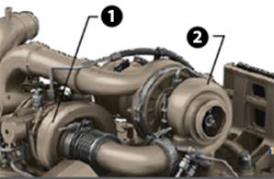 Series turbochargers
Series turbochargers

- High-pressure turbocharger
- Low-pressure turbocharger
The PowerTech PSS 13.5L (824 cu. in.) utilizes two turbochargers – a variable geometry turbocharger (VGT) and a fixed geometry turbocharger, providing the torque rise and engine responsiveness to meet varying load conditions.
Fresh air is first drawn into the low-pressure fixed geometry turbocharger and compressed to a higher pressure. The compressed air is then drawn into the high-pressure VGT where the air is further compressed. The compressed air is then routed to the charge air cooler, and then to the intake manifold. By splitting the work between two turbochargers, both can operate at peak efficiency and at a slower rotating speed.
VGT
The VGT is electronically controlled and hydraulically actuates the turbo vanes as required to maintain peak engine performance.
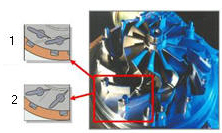 VGT vanes in exhaust flow
VGT vanes in exhaust flow

The turbocharger’s vanes are in the exhaust flow. The opening or closing of the vanes changes the outlet volume and airflow speed against the turbocharger impeller. When exhaust flow is low, the vanes are partially closed. This partial closure increases the pressure against the turbine blades to make the turbine spin faster and generate more boost pressure. The ability to keep the airflow flowing at optimum levels provides more consistent engine boost pressure and the ability to respond to load quickly across the entire engine rpm range. This system is without turbo lag as can be found on some engines. Boost pressure in the intake manifold is controlled at its optimum point for added fuel economy and performance regardless of rpm or load.
The overall benefits:
- Increased low rpm torque
- Quicker response to load
- Increased peak torque
- Improved fuel economy
- Improved performance at high altitudes
Air-to-air aftercooling
Air-to-air aftercooling lowers the intake manifold air temperature and provides more efficient cooling while reducing cylinder firing pressure and temperatures for greater engine reliability. Since low temperature air is denser, a higher volume of air flows into cylinders so the engine is capable of meeting the increasing horsepower demands.
Electronic unit fuel injection system
 Electronic unit injector
Electronic unit injector
Electronic unit fuel injection system on the 13.5 L (824 cu. in.) engine provides the following benefits:
- Variable timing control for improved emissions
- Better control at start of fuel injection for improved starting
- Elimination of nozzle service
- Camshaft-driven transfer pump draws fuel through the fuel filter
- The single fuel rail is a drilled passage in the head, eliminating the need for external lines for reduced service through the fuel filter
Engine control unit (ECU) - full authority electronic controls
This engine control unit uses signal inputs from sensors and pre-programmed performance modeling to control critical engine functions such as fuel quantity, injection timing, air-to-fuel ratio, multiple fuel injections, amount of cooled exhaust gas recirculation (EGR), and a host of other control parameters to deliver peak fuel economy and engine performance.
Each injector is controlled individually by the ECU. The ECU turns the injector on and off during each firing cycle to control the fuel delivery into each cylinder. The ECU can sense engine speed and load changes at a rate of 100 times per second and respond instantly to them. Load and speed sensing allows each cylinder’s fuel delivery rate to be adjusted independently at the individual injector. With each injection cycle, the ECU can make the following adjustments on the go:
- Number of injections
- Fuel pressure in the common rail
- Start of injection
- Duration of injection
This management system is connected to the transmission allowing the engine and transmission to respond simultaneously.
Cold weather and high altitude compensation are also precisely controlled for quality starts regardless of weather and proper power levels at high elevations.
Noise reduction
The injection system also contributes to the engine running at a decreased noise level by a process called pilot injection. The precise fuel injection capabilities allow a small amount of fuel to be injected early in the combustion process. This helps lessen the combustion knock that is commonly heard on many diesel engines. While the combustion noise reduction is most obvious at lower engine speed, pilot injection continues to function at any engine speed.
Vari-Cool™ system
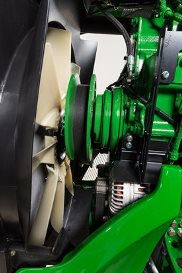 9R cooling package
9R cooling package

The Vari-Cool fan drive system precisely controls the speed of the fan in relation to the cooling requirements to maximize efficiency of the engine. The Vari-Cool system is efficient for two primary reasons:
- The belt drive used in the Vari-Cool system transfers almost 100 percent of the power from the engine to the fan.
- The variable fan speed sheave is electronically controlled only operating at the necessary speed to cool the engine and other auxiliary components.
Vari-Cool is integrated into the hood design
The Vari-Cool system is an integrated part of the hood design. Intake and outflow of air from the coolers is diverted to key openings in the hood structure. The design allows for airflow dispersion that lessens dust and crop kick-up by discharging the airflow away from the cab.
How Vari-Cool works
This electrohydraulic system uses variable speed drives. Actual fan speed is determined by the ratio differences of the top fan drive sheave to the bottom sheave.
The electronic control unit monitors various sensor inputs from the tractor and automatically changes the sheave ratio to change the fan speed. Hydraulic oil pressure is directed to the pistons that push the top inner sheave out (A), to close the gap and create a larger working diameter.
The bottom sheave (B) responds by compressing the coil spring, widening the gap between the two sheave halves, and creating a smaller working diameter to increase the fan speed.
To slow the fan, the valve opens, allowing oil to leave the piston, widening the upper sheave halves.
Automatic shutdown function
This feature monitors engine coolant temperature, engine oil pressure, and transmission oil pressures while the transmission is in the park position, and the operator is out of the seat. If any of the systems reach undesirable levels, the tractor will shut down, to help prevent further tractor damage.
AdBlue is a trademark of German Association of the Automobile Industry (VDA).
Standard CommandView™ III cab offers unsurpassed amenities
 CommandView III cab
CommandView III cab
The standard CommandView III cab offers unsurpassed visibility, operator comfort, control placement, and ride and sound quality.
Features:
- ComfortCommand™ seat with air suspension, lumbar support, swivel, fore-aft and lateral attenuation, backrest angle adjustment, adjustable left-hand armrest, and 40-degree right-hand seat swivel
- Operator presence system that warns if the operator is out of the seat while operating key functions
- Folding instructional seat
- CommandARM™ control center with integrated controls
- 4100 or 4600 Generation 4 CommandCenter™ processor
- Behind-the-seat storage
- Left-hand storage compartment
- Passive noise reduction system
- Service ADVISOR™ diagnostic system data port
- Tilt/telescoping steering wheel with position memory
- Swing-out rear window, opens 30 degrees
- Right- and left-outside mirrors (manually adjustable mirror head)
- Monitor mounts on right-hand front post and rear cab post
- Standard radio package, including AM/FM stereo and weatherband with remote controls, auxiliary input jack, four speakers, and an external antenna
- Laminated glass
- Air conditioner and heater with automatic temperature controls (ATC)
- Two 12-V convenience outlet (cigarette lighter style)
- One 12-V 3-pin outlet with adapter (provides switched and unswitched power)
- One International Organization for Standardization (ISO) nine-pin connector
- Power strip with convenience plug adapter
- Hitch control lever lock and selective control lever lock
- Two-speed and intermittent front and rear wiper with washer
- Front pull-down sunshade
- Digital cornerpost display with:
- Fuel level gauge, including low fuel warning
- Temperature gauge
- Diesel exhaust fluid (DEF) gauge, including low DEF warning
- Engine rpm
- Transmission commanded gear or speed
- Vehicle system functions, such as iTEC™ end-row guidance, that are operating
- Inside-mounted rearview mirror
- Beverage holders sized to accommodate various containers
- Interior left-hand dome light
ComfortCommand seat
 ComfortCommand seat
ComfortCommand seat
ComfortCommand seat improves ride quality and helps to reduce operator fatigue
Features include:
- Armrests, lumbar support, and backrest angle are easily adjusted to match operator preference.
- Shock absorbers dampen the motion effect of the tractor for an improved ride.
- Seat height adjustments are conveniently located on the left armrest.
- Fore-aft adjustment is easy to reach located on the left front of the seat.
- Swivel adjustment, located on the front of the seat, allows the seat to be swiveled 40 degrees to the right or eight degrees to the left of the center position.
- Operator presence switch warns if the operator is out of the seat while operating key functions.
- Seat belt retractor.
- Centered cab seat, providing excellent over-shoulder visibility.
- Adjustable shock absorber permitting ride adjustment from soft to firm to match the operator's desired comfort level.
- Removable cushions for easy cleaning.
CommandARM
 CommandARM controls
CommandARM controls
John Deere 9 Family Tractors feature the CommandARM with integrated Generation 4 CommandCenter display. The control layout of the CommandARM utilizes a clean and efficient design which groups controls by function and builds upon John Deere’s history of intuitive and ergonomic control placement and operation. The design of the CommandARM allows for a 40-degree right seat swivel and adjustable positioning matching the operator’s preference.
Controls located on the CommandARM include:
- Engine throttle
- Transmission control for e18™ transmission speed PowerShift™ transmission
- Eco mode (minimum engine speed) for e18 speed PowerShift transmission
- FieldCruise™ engine controls
- Selective control valve (SCV) controls
- AutoLoad™ controls (if equipped)
- Differential lock on/off and automatic
- iTEC™ sequence switches
- AutoTrac™ assisted steering system resume switch (if equipped)
- Radio
- Beacon light on/off
- Hazard lights on/off
- Field lights 1/2
- Heating, ventilation, air-conditioning (HVAC) system
Hydraulic controls
Hydraulic controls utilize fingertip paddle pots for raise/lower and extend/retract functions.
 Fingertip paddle pots
Fingertip paddle pots
Throttle
The throttle design incorporates buttons which control FieldCruise speed, and transmission eco settings.
 Throttle
Throttle
Tractor function controls
Located just to the right of the throttle is the Auto-Trac activation button and four sequence controls for iTEC functions. Behind the iTEC sequence controls there are buttons which control the activation and deactivation of differential lock. Differential lock can also be activated by the foot switch on the cab floor.
 AutoTrac resume and iTEC strip
AutoTrac resume and iTEC strip
Controls for radio, lights, rotary beacon (if equipped), hazard flashers, and HVAC system are located to the center-right on the CommandARM, along with power take-off (PTO) for rear PTO.
 Radio, HVAC, hazard flashers, and PTO controls
Radio, HVAC, hazard flashers, and PTO controls
Seat swivel
The design of the CommandARM allows for up to 40 degrees of right-hand seat swivel.
 Seat swivel
Seat swivel
 40-degree seat swivel shown
40-degree seat swivel shown
CommandCenter
 Generation 4 CommandCenter
Generation 4 CommandCenter
The Generation 4 CommandCenters features fast adjustment of tractor functions and controls and are integrated into the CommandARM to create a seamless control center.
The following functions can be adjusted and accessed using the CommandCenter display:
- Hydraulic settings
- Hitch settings
- Transmission settings
- FieldCruise
- iTEC programming functions
- Radio
- Lights
- Add all functionality – diagnostics, display settings, etc.
The Generation 4 CommandCenter systems have the capability of Remote Display Access (RDA). RDA allows improved communication between an offsite farm manager or dealer and the equipment operator. The user can view exactly what the operator sees on the GreenStar™ 3 2630 Display and Generation 4 CommandCenter from almost any internet-connected device. RDA is available on the 4600 and 4100 CommandCenter and allows for an increase in productivity with quicker problem resolution. By using RDA, the cost of operation will decrease due to reduced labor and travel costs, and maximum efficiency will increase profit.
JDLink™ services and Service ADVISOR™ diagnostic systems
JDLink
 JDLink Dashboard
JDLink Dashboard
JDLink is the John Deere telematics system designed for operators and managers who desire to take their operations to the next level of productivity and efficiency without leaving the office. Whether it is receiving an e-mail or text message, users can manage the operation in real-time without being in the cab. Using the power of JDLink can optimize productivity, increase uptime, and boost profits with JDLink information all accessible from a laptop, desktop, or mobile device.
JDLink Ultimate provides enhanced machine performance and utilization information that can only be achieved through direct communication with on-board machine controllers. Utilizing John Deere-exclusive telematics technology, users can remotely link to Ultimate-compatible machines to achieve a new level of optimization.
NOTE: Mobile device compatibility and functionality varies.
Monitor assets, performance, and more with JDLink:
- Increase uptime and reduce time spent managing equipment with JDLink Ultimate
- Coordinate machine and labor logistics
- Unleash new possibilities with wireless machine connectivity
- Locate machines on-the-go with the JDLink app for iPhone®, iPad® or Android™ devices
- Leverage common components from the JDLink system to enable remote support and machine monitoring
- Industry-exclusive Service ADVISOR Remote with JDLink (Canada link)
For more information on JDLink activations and subscriptions, visit www.StellarSupport.com.
NOTE: JDLink is not available in all geographic regions.
Service ADVISOR
 Service ADVISOR
Service ADVISOR
Service ADVISOR diagnostics greatly assist in reducing service costs and downtime. It allows the John Deere service technician to readily extract vital information about tractor malfunctions through the Service ADVISOR data port. Diagnostic codes and controller area network (CAN) bus statistics stored by the tractor and visible in the CommandCenter™ display are used by service technicians to isolate, identify, and resolve problems.
Diagnostics and CAN bus statistics are not normally used by the operator. Access and use of trouble codes should only be done by a qualified, factory-trained John Deere service technician.
Service ADVISOR Remote
Service ADVISOR Remote takes the machine connectivity of JDLink and takes it one step further. With Service ADVISOR Remote, machines can be diagnosed remotely, saving the cost of a field service call. For example, diagnostic trouble codes can be reset and software updates can be uploaded remotely.
Apple, iPhone, and iPad are trademarks of Apple Inc. Android is a trademark of Google LLC.
Power take-off (PTO), 1-3/4 1000 rpm
 PTO and shield
PTO and shield
Fully independent 1000-rpm PTO is available as a factory- or field-installed option.
- Available on all 9 Family Ag Tractors.
- 4.45-cm (1-3/4-in.) diameter shaft.
9R – When the PTO is on and ground speed is 0.5km/h (0.31 mph) or less; PTO is limited to 335 hp.
9RT – When the PTO is on and ground speed is 0.5km/h (0.31 mph) or less; PTO is limited to 329 hp.
9RX – When the PTO is on and ground speed is 0.5km/h (0.31 mph) or less; PTO is limited to 335 hp.
See the specs page for model rated PTO horsepower.
The PTO shield has three positions — neutral, up, and down. Use the neutral position when the PTO is connected and ready for use. Use the up position for added clearance when connecting the PTO shaft to the tractor. The down position is used when the PTO is not connected and extra visibility to the drawbar is desired.
Electrohydraulic PTO control
The 9 Family Tractors utilizes an electrohydraulic PTO-engagement switch to activate the optional 1000-rpm PTO.
If PTO option is not installed, a storage compartment is located on the rear of the tractor.
 Rear storage compartment on 9R
Rear storage compartment on 9R
3-point hitch and CommandCenter™ controls boost productivity
3-point hitch
 3-point hitch on 9RX
3-point hitch on 9RX
The 9 Family Tractors are designed to maximize performance for different applications. The 9R, 9RT, and 9RX Series Tractors offer two different hitch options:
9370R |
9420R/9420RX |
9470R/9470RT/9470RX |
9520R/9520RT/9520RX |
9570R/9570RT/9570RX |
9620R/9620RX |
|
Category 4N/3 with quik-coupler, all axle diameters |
Optional – 6804 kg (15,000 lb) |
Not available |
||||
Category 4N/3 with quik-coupler, 120-mm (4.7-in.) axles required |
Optional – 9072 kg (20,000 lb) |
Not available |
||||
Category 4/4N with quik-coupler, all diameters axles |
Optional: 6804 kg (15,000 lb) |
|||||
Category 4/4N with quik-coupler, 120-mm (4.7-in.) axle required |
Optional: 9072 kg (20,000 lb) |
|||||
CommandARM™ controls
 Hitch controls
Hitch controls
 Field-installed 3–point hitch controls under armrest on CommandARM
Field-installed 3–point hitch controls under armrest on CommandARM
To help boost productivity, a field-installed kit with 3-point hitch controls can be purchased. If this option is selected, control buttons will be located on the 9 Family Tractor’s CommmandARM to access individual hitch settings. There are three buttons — set, lock, and load depth. There is also a rotary encoder that allows for finite movements of the hitch. The rotary encoder is detented, so it clicks for each movement. Additionally, hitch adjustment controls are located under the CommandARM for raise/lower rate.
Hitch load depth
The load depth feature is a useful tool designed to increase performance in tillage applications. Load depth adjustments allow the operator to make adjustments to hitch draft responsiveness.
Draft control helps maintain the operating depth in varying conditions, such as rolling terrain, and varying soil densities.
An additional feature with load depth control is the hitch slip option. Hitch slip uses wheel slip data to supplement the draft control system. If the wheels slip, the 3-point hitch lifts to allow the tractor wheels to maintain traction with the ground. Once the slip condition is no longer present, the hitch lowers to the required depth as determined by the hitch command and load depth settings.
Both of these hitch command options are easily programmable in the CommandCenter display by pressing the load depth shortcut key, followed by using the thumbwheel and confirm key to dial in the desired settings.
Hitch, external remote control switch
 3-point hitch switch on fender of 9R
3-point hitch switch on fender of 9R
For added operator convenience, a 3-point hitch remote control switch is located on top of the left rear fender for 9R, 9RT, and 9RX Tractors. The external remote switches enable the operator to raise and lower the 3-point hitch from behind the tractor while hooking to implements.
High-flow hydraulics, 435-L/min (115-gpm) system
Dual hydraulic pump system
 Selective control valve (SCV) stack
Selective control valve (SCV) stack
Optional high-flow hydraulics are available on 9 Family Tractors by ordering code 3270. The high-flow hydraulic system provides an additional 215 L/min (57 gpm) of flow for a total of 435 L/min (115 gpm). This system is ideal for hydraulic fan motor demands. This system is recommended for agricultural implements with continuous flow requirements. When maximum hydraulic pump capacity is reached, multiple functions will continue to operate at the same proportional flow rate.
The 9 Family Ag High-Flow Tractors have two parallel hydraulic systems. The benefit of this system is that functions can be split between the two systems. Functions that require high flow and low pressure can be combined on one system (for example, air seeder fans, and planter motors). Functions that require high pressure and low-flow can be connected to the remaining system (for example, implement lift, fold, and constant down-pressure systems).
Following these guidelines allows the hydraulic system to run cooler as it prevents both hydraulic pumps from running at high pressure. In general, pumps forced to run at both high pressure and high flows generate much more heat than a pump running at a lower flow or lower pressure.
The system operates with two hydraulic pumps:
- Pump 1 - provides hydraulic flow of up to 215 L/min (58 gpm) to SCVs 1, 2, and 3. These SCVs are useful for operating lift/lower and other cylinder type hydraulic needs.
- Pump 2 - attaches in front of pump 1 and provides hydraulic flow of up to 215 L/min (57 gpm) to SCVs 4, 5, and 6. These SCVs are useful for operating hydraulic motors to drive air/fan or vacuum systems on seeding/planting equipment.
- All SCV oil returns to one common hydraulic reservoir.
Eight-section SCV stack for high-flow requirements
 Five 1.3-cm (1/2-in.) couplers (A) and three 1.9-cm (3/4-in.) couplers (B)
Five 1.3-cm (1/2-in.) couplers (A) and three 1.9-cm (3/4-in.) couplers (B)
For applications requiring continuous high hydraulic flow or multiple 1.9-cm (3/4-in.) hydraulic connections, this SCV stack is designed to maximize efficiency of the hydraulic system while providing additional flow using 1.9-cm (3/4-in.) couplers. Arrangement of the 1.9-cm (3/4-in.) couplers are split between the tractor’s dual hydraulic pumps to even the hydraulic load on each pump. Increasing coupler size from 1.3 cm (1/2 in.) to 1.9 cm (3/4 in.) allows an additional 26.5 L/min (7 gpm) or 17 percent more hydraulic flow through each coupler and reduces backpressure for hydraulic functions such as dual fan motors associated with the Air Power™ 2 system equipped on John Deere C850 Air Carts. With three 1.9-cm (3/4-in.) couplers available, operators can connect to other high-demand functions such as raise/lower. The 1.9-cm (3/4-in.) couplers also allow higher fan motor speeds for high-rate applications and allow more power to the ground due to less restriction on the hydraulic system.
NOTE: This SCV configuration is available on all double-reduction) axle 9420R to 9570R Tractors with high-flow hydraulics and all 9RX Tractors with high-flow hydraulics. This eight-section SCV stack does not include hydraulic Intelligent Power Management (IPM) software.
 SCV couplers
SCV couplers
Connections to 1.3-cm (1/2-in.) and 1.9-cm (3/4-in.) couplers are quick and simple for operators with a split SCV stack configuration at a comfortable connection height.
 SCV connections in a stack configuration
SCV connections in a stack configuration
General maintenance
 9R, 9RT, and 9RX service access
9R, 9RT, and 9RX service access
Regular service and maintenance are essential to the performance, productivity, and longevity of all farm machinery.
Maximum uptime is an important element of productivity.
- 9 Family service points are quick and simple to check.
- Greater accessibility improves serviceability.
All items in the daily service schedule can be performed without the use of tools:
- Engine oil, hydraulic oil, coolant level, and water separator can be conveniently accessed from ground level without having to open the hood. Engine oil can be checked by simply removing one small engine side panel.
 Engine oil service point
Engine oil service point
- Engine can be easily accessed by simply raising the one-piece hood and removing two engine side panels for more periodic maintenance checks.
- Single-point latch mechanism ensures easy hood opening and closure.
NOTE: Always refer to the operator’s manual for complete maintenance and service recommendations.
Refueling
 Fuel tank on the 9R
Fuel tank on the 9R
 Refueling
Refueling
The 9R Series Tractors fuel tank is located over the rear axle. The fuel tank features a dual fill design. This design allows the machine to be filled from either side of the fuel tank. A fuel nozzle holder is located when the operator positions themselves on the gudgeon platform to fill the fuel tank.
The diesel exhaust fluid (DEF) tank is located on the left-hand side of the tractor indicated by a blue cap. It is fillable from ground level and has a protective shield to keep debris out of the fill neck.
Model |
Diesel |
DEF |
9370R |
1211 L (320 gal.) | 120 L (31.7 gal.) |
9420R |
1514 L (400 gal.)* | 120 L (31.7 gal.) |
9470R |
1514 L (400 gal.)* | 120 L (31.7 gal.) |
9520R |
1514 L (400 gal.) | 120 L (31.7 gal.) |
9570R |
1514 L (400 gal.) | 120 L (31.7 gal.) |
9620R |
1514 L (400 gal.) | 120 L (31.7 gal.) |
*When equipped with double-reduction axle. 1211-L (320-gal.) when equipped with single-reduction axle.
 Fuel tank on the left side of 9RT
Fuel tank on the left side of 9RT
The 9RT fuel tank is located behind the cab; the fuel fill is located conveniently on the left-hand main platform.
The 9RT Series Tractors all feature a DEF tank capacity of 93.9 L (24.8 gal.). The fill location is near the diesel fill location.
Model |
Diesel |
DEF |
9470RT |
1325 L (350 gal.) | 93.9 L (24.8 gal.) |
9520RT |
1325 L (350 gal.) | 93.9 L (24.8 gal.) |
9570RT |
1325 L (350 gal.) | 93.9 L (24.8 gal.) |
Model |
Diesel |
DEF |
9470RX |
1514 L (400 gal.) | 120 L (31.7 gal.) |
9520RX |
1514 L (400 gal.) | 120 L (31.7 gal.) |
9570RX |
1514 L (400 gal.) | 120 L (31.7 gal.) |
9620RX |
1514 L (400 gal.) | 120 L (31.7 gal.) |
NOTE:
- John Deere supports the usage of bio diesel. Bio diesel should meet ASTM D6751 (US) or EN 14214 (European) fuel quality standards.
- Tractors receive fuel containing a 2 percent bio-diesel blend at the factory.
- Acceptable blend levels may vary by geographic region.
- Diesel exhaust fluid will freeze when exposed for longer than three hours to conditions below -11°C (12.2° F).
For more information about the use of bio-diesel in John Deere engines, refer to www.JohnDeere.com/biodiesel.
DEF fill
9R, 9RT, and 9RX Series Tractors feature an easy-to-use DEF fill system. The 9R and 9RX feature a ground-level fill location, and DEF fill on 9RT is conveniently located on the step platform.
| Machine | DEF tank capacity |
| 9R | 120 L (31.7 gal.) |
| 9RT | 93.9 L (24.8 gal.) |
| 9RX | 120 L (31.7 gal.) |
 DEF tank on 9R/9RX
DEF tank on 9R/9RX
In-line DEF filter
9R, 9RT, and 9RX Series Tractors feature an in-line DEF filter to help protect the DEF pump from any contamination in the DEF tank. This in-line DEF filter is easily serviced with a drain plug to drain any remaining DEF from the filter housing and a replaceable cartridge-style filter.
 In-line DEF filter
In-line DEF filter
Severe-duty water separator, if equipped
The severe-duty water separator can extend service intervals and helps to protect the tractor’s fuel system from damage associated with lower-quality fuel.
Simply open the drain valve on the bottom of the separator and drain accumulated water.
NOTE: Cummins® QSX 15 L (915.4-cu in.) engines cannot be equipped with a severe-duty water separator; however, the fuel filter has separating capabilities like the primary filter on John Deere Power System engines.
Engine access
 Engine access on 9RX
Engine access on 9RX
The tilt hood and side panel design provides additional engine compartment protection. The 9R, 9RT, and 9RX hoods feature the same design for access to engine components.
Pull out the hood release (located on the front, left side) and tilt hood back to open. Engine side panels are quickly and easily removed for access to periodic maintenance items.
 Removing side engine panel
Removing side engine panel
Transmission, hydraulic, and axle oil level
 Sight gauge on 9R and 9RX
Sight gauge on 9R and 9RX
 Sight gauge on 9RT
Sight gauge on 9RT
A sight glass for the transmission, hydraulic, and axle oil level is located at the back right side of the gudgeon, indicating proper oil levels, and an oil fill neck is located on the back right side of the gudgeon for the 9R and 9RX Series Tractor. The oil fill is located on the top of the common reservoir on the left side of the 9RT Series Tractor and a fill tube is located between the steps and engine of the tractor.
- Provides increased filter capacity compared to previous 9R and 9RT Series Tractors
- Transmission, hydraulic, and axle oil should be changed every 1500 hours
- Filter should be changed every 1500 hours unless filter restriction code occurs
- Daily and 10-hour inspections of the transmission hydraulic oil level are recommended
NOTE: The tractor should be off and parked on level ground with the hitch in the lowered position when checking the oil level.
- Sight glass observations will be significantly higher with hot oil temperatures and lower with cold oil or if engine has not run long enough.
NOTE: Oil level above the top mark on the sight glass can result in power loss and heat generation during transport applications.
Primary air filter access
 Primary engine air filter inspection
Primary engine air filter inspection
On the 9R and 9RX, the primary engine air filter is accessible from the left-hand platform for replacement annually or as operating conditions require. The filter is aspirated and extends filter life in dusty conditions by aspirating more than 95 percent of incoming dust. Aspirator suction is created by utilizing the air flow from the cooling fan.
On the 9RT, the primary engine air filter is located at ground level on right side of tractor.
Oil change intervals
 Engine oil check/fill location
Engine oil check/fill location
Tractors with the 9.0L (549.2-cu in.) and 13.5L (823.2-cu in.) John Deere Power Systems engines feature a 500-hour change interval when using approved John Deere Plus-50™ II oil and a John Deere oil filter.
Tractors equipped with the Cummins QSX 15-L (915.4-cu in.) engine have a 400-hour engine oil and oil filter change interval.
- Previous initial oil and filter change at 100 hours is no longer required due to the factory fill of Break-In™ Plus oil.
- If using anything other than John Deere Plus-50 II oil, a 250-hour change interval is required. CJ-4 must still be used.
- Only use ultra-low sulfur diesel fuel and CJ-4, ACEA E9, or ACEA E6 oil.
- An oil change of 500 hours is possible when using fuel with less than 15 parts per million (ppm) of sulfur, along with John Deere Plus-50 II oil.
See the tractor's operator's manual for oil change intervals and further details.
Battery access
 Battery location on 9R and 9RX
Battery location on 9R and 9RX
 Battery location on 9RT
Battery location on 9RT
The 9R and 9RX battery location is behind the left-hand step assembly. There are three bolts that secure the swinging step assembly that need to be removed to completely access the batteries. The 9RT top step of the platform conceals the tractor’s three 12-V batteries with 2775 CCA (925-CCA each). Tractors with the Cummins X15 engine will have four 12-V batteries in the same location as tractors equipped with John Deere Power System engines.
Although the batteries are maintenance free, conditions such as long periods of operation at high ambient temperatures and excessive engine cranking may require adding water.
Battery boost terminal
 Battery boost terminal
Battery boost terminal
On the 9R and 9RX, a battery boost terminal is located on the left-hand side of the engine for convenient and proper boost assisted starting.
Fuse and relay panel
 Fuse and relay panel
Fuse and relay panel
The electrical fuse and relay panel is located behind the operator’s seat and just below the cab's rear window. Simply lift up on the operator manual cover for access.
- Contains easy-to-replace automotive blade-type fuses and relays for quick servicing.
- Spare fuses are provided for each amperage size used.
The diode module contains many of the diodes contained in the system:
- If a diode problem occurs, simply replace the diode module for easy service and increased uptime.
- Relays are also fully interchangeable for quick service.
Electrical system (smart load center)
The electrical system provides a full controller area network (CAN) bus based system on the tractor for improved tractor implement integration and flexibility. Incorporated with the system is a smart load center, which provides fewer fuses, fewer connectors, and simplified wiring for increased reliability.
The solid-state load center’s primary function is to control the majority of high-current loads, such as fender floodlights and the horn. This electronic circuitry will monitor loads and voltages to provide fast reaction time and the ability to alert the operator if a circuit overloads or if voltage is out of specification – for example, open circuit (undercurrent) or short circuit (overcurrent).
Cab air filters
 Cab fresh air filter inspection
Cab fresh air filter inspection
 Cab recirculation filter
Cab recirculation filter
The cab fresh air filter is conveniently located beneath the left side of the cab for all 9 Family products:
- External service means no mess in the cab from dusty filters
- Filter housing acts as a dust accumulator compartment
- Hand screw eliminates need for tools
- Replace cab fresh air filter every 1000 hours or sooner if plugged or damaged
Cab air recirculation filter
Cab air recirculation filter is located in the roof liner above the operator. 70 percent of the total air volume is recirculated with a blanket effect for enhanced operator comfort.
- Replace cab air recirculation filter every 1000 hours or sooner if plugged or damaged.
Cab air filters are not designed to filter out harmful chemicals. Follow the instructions in the implement operator’s manual and those given by the chemical manufacturer when using agricultural chemicals.
Windshield washer
 Windshield washer bottle on 9R and 9RX
Windshield washer bottle on 9R and 9RX
The windshield washer bottle is optional on 9R and 9RX Tractors and is located on the left side of the tractor near the DEF fill point. On 9RT Tractors, it is located on the right-side frame.
Maintenance-free U-joint
Maintenance-free U-joint bearings require no servicing to reduce maintenance time.
Toolbox
 Toolbox for 9R, 9RT and 9RX
Toolbox for 9R, 9RT and 9RX
A convenient toolbox is located on the left-hand side of the front frame for tool storage and comes standard on all 9R, 9RT, and 9RX Series Tractors.
9R and 9RX Series Tractors have an additional storage box conveniently located on top the left-hand platform.
The 9RT has an additional toolbox conveniently located next to the left side of the batteries for additional storage.
Cummins is a trademark of Cummins, Inc.
e18™ PowerShift™ transmission with Efficiency Manager™ feature
The e18 transmission delivers smooth shifting and intuitive controls in a reliable 18-speed PowerShift transmission. The e18 transmission with enhanced Efficiency Manager is standard equipment on all 9 Family Tractors.
The e18 has evolved from more than 50 years of John Deere PowerShift technology. With more automatic features, the e18 is easy to operate for all levels of operators and operations. It features three modes of operation, full AUTO, custom, and manual modes. Full AUTO and custom modes manage the engine and transmission to match the desired ground speed to the field conditions. These two modes are ideal for most conditions and take the guess work out of operation. Manual mode is perfect for operators looking to operate the e18 like a traditional PowerShift by bump shifting and managing the engine throttle to their liking.
As the next generation of PowerShift technology, the e18 delivers the strength to handle sudden, high-torque power loads while maintaining responsive, quick, and smooth shifts.
e18 controls
 Shift lever and hand throttle
Shift lever and hand throttle
CommandCenter™ controls
 254-mm (10-in.) Generation 4 CommandCenter
254-mm (10-in.) Generation 4 CommandCenter
The CommandCenter is the central information system for tractors and allows the operator to program various settings tailored to a specific operation.
To access the tractor’s transmission settings, press the transmission shortcut button on the CommandCenter shortcut bar.
 CommandCenter transmission shortcut button
CommandCenter transmission shortcut button
Operating modes
The e18 application settings employ three modes to take full advantage of the engine-transmission communication: Full AUTO mode, custom mode, and manual mode.
Full AUTO mode
 Full AUTO main page
Full AUTO main page
Full AUTO mode manages the tractor’s engine and transmission inputs to reach and maintain the desired ground speed set by the operator. This means the tractor will manage shifts and engine rpm to operate at the most efficient level possible. Operators have the ability to set the maximum forward and reverse speeds for their particular applications. In full AUTO mode the operator can adjust the desired ground speed in two ways, by conducting a traditional bump shift or by rotating the dial on the thumb wheel.
When shifting in full AUTO mode, the transmission shifts set speeds and does not always shift gears, meaning the transmission may not necessarily shift gears if it can reach the desired ground speed with a slightly higher or lower engine rpm. Efficiency Manager is automatically engaged while operating in full AUTO mode. As a result, shifting will not take the tractor out of Efficiency Manager in full AUTO mode.
Custom mode
 e18 custom transmission page
e18 custom transmission page
Custom mode operates similar to full AUTO mode but allows operators to adjust operating parameters to meet a specific operation. It also has the ability to activate eco mode for a higher level of operation.
 Eco button
Eco button
 Display screen
Display screen
Eco allows two minimum engine speeds to be set. Operators can turn eco on and off by either pushing the eco button on the side of the throttle or by selecting eco in the transmission settings page of the CommandCenter controls. For example, operators may choose to turn eco on during transport to utilize a lower minimum engine speed and then turn eco off while operating in the field where a higher minimum engine speed is desired.
 Custom settings page
Custom settings page
In the advanced settings page, operators can customize the auto shift engine speed droop as a percentage of the full engine speed. In addition, the load anticipation feature can be enabled for the hitch engagement, hydraulic engagement, or both.
Manual mode
Manual mode operates very similarly to a traditional PowerShift transmission with Efficiency Manager.
In manual mode the operator manages the engine and transmission inputs by controlling the shift lever and hand throttle.
 Manual mode page
Manual mode page
Efficiency Manager
 Set speed buttons and set speed adjuster
Set speed buttons and set speed adjuster
Efficiency Manager is automatically enabled in auto and custom modes. Efficiency Manager can be turned on in manual mode by selecting the set speed one or set speed two button on the CommandARM™ console. The set speed adjuster on the top of the single-lever gear selector allows the operator to dial in the desired ground speed to establish set speed one or two. Once engaged, Efficiency Manager will manage the engine rpm and gear selection to maintain the desired working speed. To reach the desired set speed, the throttle must be set to full engine rpm.
e18 operation
 e18 operation
e18 operation
Setting start-up gears
The 9 Family Tractors default to 7F and 2R at start up. However, these default start-up gears can be adjusted from 1-13F and 1-3R through the CommandCenter. Refer to the operator’s manual for additional information.
 Start-up gears in advanced settings
Start-up gears in advanced settings
9R Series Tractor - e18-speed chart for PowerShift transmission with Efficiency Manager
9R table
Group 47 tires |
Group 48 tires |
|||
Tire size |
(480R46, 20.8R42, 520R42, 620R42, 710R38) |
(480R50, 520R46, 620R46, 710R42, 800R38) |
||
Engine (rpm) |
2100 |
2100 |
||
18-speed gear |
km/h |
mph |
km/h |
mph |
Forward gears |
||||
F1 |
4.0 |
2.5 |
4.2 |
2.6 |
F2 |
4.8 |
3.0 |
5.0 |
3.1 |
F3 |
5.3 |
3.3 |
5.6 |
3.5 |
F4 |
5.9 |
3.7 |
6.2 |
3.9 |
F5 |
6.5 |
4.0 |
6.8 |
4.3 |
F6 |
7.3 |
4.5 |
7.6 |
4.8 |
F7 |
8.0 |
5.0 |
8.5 |
5.3 |
F8 |
9.0 |
5.6 |
9.5 |
5.9 |
F9 |
9.9 |
6.1 |
10.4 |
6.5 |
F10 |
11.0 |
6.9 |
11.6 |
7.2 |
F11 |
12.2 |
7.6 |
12.9 |
8.0 |
F12 |
13.5 |
8.4 |
14.2 |
8.8 |
F13 |
15.0 |
9.3 |
15.8 |
9.8 |
F14 |
16.6 |
10.3 |
17.5 |
10.9 |
F15 |
20.5 |
12.8 |
21.6 |
13.4 |
F16 |
25.3 |
15.7 |
26.6 |
16.5 |
F17 |
31.2 |
19.4 |
32.9 |
20.4 |
F18 |
38.5 |
23.9 |
40.5 |
25.2 |
Reverse gears |
||||
R1 |
3.9 |
2.4 |
4.1 |
2.5 |
R2 |
5.3 |
3.3 |
5.6 |
3.5 |
R3 |
5.9 |
3.7 |
6.2 |
3.9 |
R4 |
8.0 |
5.0 |
8.5 |
5.3 |
R5 |
9.0 |
5.6 |
9.5 |
5.9 |
R6 |
12.2 |
7.6 |
12.9 |
8.0 |
Group 47 tire based on 710/70R38
Group 48 tire based on 800/80R38
9RT and 9RX Series Tractor - e18-speed chart for PowerShift transmission with Efficiency Manager
9RT and 9RX table
|
9RT |
9RX |
||
Engine (rpm) |
2100 |
2100 |
||
18-speed gear |
km/h |
mph |
km/h |
mph |
Forward gears |
|
|
|
|
F1 |
4.0 |
2.5 |
4.0 |
2.5 |
F2 |
5.0 |
3.1 |
4.9 |
3.0 |
F3 |
5.5 |
3.4 |
5.5 |
3.4 |
F4 |
6.1 |
3.8 |
6.1 |
3.8 |
F5 |
6.8 |
4.2 |
6.7 |
4.2 |
F6 |
7.6 |
4.7 |
7.5 |
4.7 |
F7 |
8.4 |
5.2 |
8.3 |
5.2 |
F8 |
9.3 |
5.8 |
9.2 |
5.7 |
F9 |
10.3 |
6.4 |
10.2 |
6.3 |
F10 |
11.4 |
7.1 |
11.4 |
7.1 |
F11 |
12.6 |
7.8 |
12.6 |
7.8 |
F12 |
14.1 |
8.7 |
14.0 |
8.7 |
F13 |
15.6 |
9.7 |
15.5 |
9.6 |
F14 |
17.3 |
10.7 |
17.2 |
10.3 |
F15 |
21.4 |
13.3 |
21.3 |
13.2 |
F16 |
26.3 |
16.3 |
26.2 |
16.3 |
F17 |
32.3 |
20.1 |
32.2 |
20.0 |
F18 |
39.8 |
24.7 |
39.6 |
24.6 |
Reverse gears |
|
|
|
|
R1 |
4.0 |
2.5 |
4.0 |
2.5 |
R2 |
5.5 |
3.4 |
5.5 |
3.4 |
R3 |
6.1 |
3.3 |
6.1 |
3.8 |
R4 |
7.3 |
3.8 |
8.3 |
5.2 |
R5 |
9.3 |
5.8 |
9.2 |
5.7 |
R6 |
12.6 |
7.8 |
12.6 |
10.3 |
9RX Tractor narrow undercarriage recommended transport speed
9RX Series Tractors equipped with 45.7-cm (18-in.) and 61-cm (24-in.) tracks feature a maximum speed of 42 km/h (26 mph).
9RX Series Tractors equipped with 45.7-cm (18-in.) or 61-cm (24-in.) tracks are advised to reduce ground speed based on axle load. 9RX Series Tractors equipped with 45.7-cm (18-in.) tracks will have a top speed set at the factory of 31 km/h (19 mph). Maximum speed may be adjusted up to 42 km/h (26 mph) upon review of the transport speed recommendations in the Operator’s Manual.
The speed reduction allows the undercarriage components and tracks to dissipate heat buildup caused by the higher axle loads, reducing undercarriage component and track damage. Increasing mid-roller surface area will increase the undercarriage ability to dissipate heat.
Narrow undercarriage with 45.7-cm (18-in.) tracks feature a narrower mid-roller matched to track width. This results in a smaller mid-roller surface area than 61-cm (24-in.) tracks, which are also matched to track width.
Producers who desire a 9RX machine for row-crop work and who also transport long distances with high axle loads should understand the limitations of the 45.7-cm (18-in.) and 61-cm (24-in.) tracks. 61-cm (24-in.) tracks with a greater mid-roller surface area will provide greater undercarriage and machine performance in transport while maintaining the ability to perform row-crop work. Comparing the transport speed recommendations for 45.7-cm (18-in.) and 61-cm (24-in.) tracks, the speed reduction is higher for 45.7-cm (18-in.) tracks for the same axle load.
9RX Series Tractors with a wide undercarriage and 76.2-cm (30-in.) or 91.4-cm (36-in.) tracks do not feature a speed reduction with increased axle load.
 9RX in transport
9RX in transport
9RX Series Tractor owners and operators need to be aware of axle loads and the recommended speed. The operator’s manual for both the machine and implement will have information on advised transport speeds. 9RX Series Tractors equipped with narrow undercarriage will also feature an in-cab window decal and reference card stored in the armrest for quick guidance on recommended transport speed based on axle load. Many implements may have a lower recommended transport speed than the tractor,; it is always advised to follow the lowest recommended transport speed.
 Maximum transport speed with axle weight
Maximum transport speed with axle weight
Window decal
| Window decal | |||||
| Single axle weight | 18 inch track max. | 24 inch track max. | |||
| (kg) | (lbs) | km/h | mph | km/h | mph |
| Tractor | 42 | 26 | 42 | 26 | |
| 15,900 | 35,000 | 34 | 21 | 42 | 26 |
| 20,400 | 45,000 | 26 | 16 | 37 | 23 |
| 24,900 | 55,000 | 21 | 13 | 32 | 20 |
Speed increments
| 1 mph increment | |||||||
| Single axle weight | 18 inch track max. | Single axle weight | 24 inch track max. | ||||
| (kg) | (lbs) | km/h | mph | (kg) | (lbs) | km/h | mph |
| 14,500 | 32,000 | 42 | 26 | 16,800 | 37,000 | 42 | 26 |
| 15,000 | 33,000 | 37 | 23 | 18,100 | 40,000 | 40 | 25 |
| 15,400 | 34,000 | 35 | 22 | 19,500 | 43,000 | 39 | 24 |
| 15,900 | 35,000 | 34 | 21 | 20,900 | 46,000 | 37 | 23 |
| 16,300 | 36,000 | 32 | 20 | 22,200 | 49,000 | 35 | 22 |
| 17,200 | 38,000 | 31 | 19 | 23,600 | 52,000 | 34 | 21 |
| 18,100 | 40,000 | 29 | 18 | 24,900 | 55,000 | 32 | 20 |
| 19,500 | 43,000 | 27 | 17 | 27,200 | 60,000 | 31 | 19 |
| 20,900 | 46,000 | 26 | 16 | ||||
| 22,200 | 49,000 | 24 | 15 | ||||
| 23,600 | 52,000 | 23 | 14 | ||||
| 25,400 | 56,000 | 21 | 13 | ||||
| 27,200 | 60,000 | 19 | 12 | ||||
Implement speed recommendations
| Application | Implement | Payload | Total tractor | Rear axle load (lbs) | Front axle load (lbs) | 18 inch (mph) | 24 inch (mph) |
| Other | 60' 2410C applicator | 400 | 61,400 | 30,000 | 32,000 | 26 | 26 |
| Primary Tillage | 9 shank 2720 (without rolling baskets) | 500 | 61,500 | 30,000 | 32,000 | 26 | 26 |
| Primary Tillage | 11 shank 2730 (gangs, without rolling baskets) | 484 | 61,484 | 30,000 | 32,000 | 26 | 26 |
| Secondary Tillage | 45' 2210LL cultivator | 1100 | 62,100 | 31,000 | 31,000 | 26 | 26 |
| Secondary Tillage | 40' 2623 VT | 1800 | 62,800 | 32,000 | 31,000 | 26 | 26 |
| Other | 60' 2510L 2400 gal (empty) | 3608 | 64,608 | 34,000 | 30,000 | 22 | 26 |
| Other | 1100 bu grain cart empty (Kinze 1100) | 3950 | 64,950 | 35,000 | 30,000 | 21 | 26 |
| Secondary Tillage | 45' 2310 mulch finisher | 4200 | 65,200 | 35,000 | 30,000 | 21 | 26 |
| Other | 1500 bu grain cart empty (Brent Avalanche 1596) | 3800 | 64,800 | 35,000 | 30,000 | 21 | 26 |
| Other | 1000 bu grain cart loaded (Brent 1082) | 4710 | 65,710 | 36,000 | 30,000 | 20 | 26 |
| Other | 1500 bu grain cart empty (Kinze 1500) | 5250 | 66,250 | 37,000 | 30,000 | 19 | 26 |
| Other | 1500 bu grain cart empty (Brent Avalanche 1596) | 5500 | 66,50 | 37,000 | 30,000 | 19 | 26 |
| Other | 1100 bu grain cart loaded (Kinze 1100) | 6280 | 67,280 | 38,000 | 29,000 | 19 | 25 |
| Other | 1100 bu grain cart loaded (Kinze 1500) | 7380 | 68,380 | 39,000 | 29,000 | 18 | 25 |
| Planters | DB60 47R15 CCS | 8340 | 69,340 | 41,000 | 29,000 | 17 | 24 |
| Planters | DB90 Planter | 12,300 | 73,300 | 46,000 | 27,000 | 16 | 23 |
| Planters | 1775NT 24R drawbar (need to verify) | 13,000 | 74,000 | 47,000 | 27,000 | 15 | 22 |
| Planters | DB120 Planter | 17,600 | 78,600 | 54,000 | 25,000 | 13 | 20 |
| Other | Hitch load | 15,000 | 76,000 | 54,000 | 22,000 | 13 | 20 |
NOTE: Example implements are for reference and direction only. Weigh the tractor and the amount of weight on the axle to determine the final recommended speed. Weights of implements will vary due to different configurations available between tractor and implement. Never exceed the maximum speed recommendation of any implement.
For producers who wish to limit vehicle top speed, transmission settings can be adjusted on the CommandARM™ display or user profiles can be established which locks out the ability to change vehicle top speed by the operator unless they enter the PIN.
9RX 304.8-cm (120-in.) track spacing options
Beginning with model year 2019 production, 9RX Series Tractors equipped with 76.2-cm (30-in.) and 91.4-cm (36-in.) tracks can be equipped with industry-exclusive, factory-installed track spacing set at 304.8-cm (120-in.).
9RX Series Tractors equipped with 304.8-cm (120-in.) track spacing provide increased stability, allow producers to operate on 304.8-cm (120-in.) centers for controlled traffic farming, and provide improved track-to-frame clearance for better access to the undercarriage for serviceability and material cleanout. John Deere is the first and only tractor manufacturer to offer a 304.8-cm (120-in.) track spacing option on four-track tractors with 76.2-cm (30-in.) and 91.4-cm (36-in.) tracks up to 462.3 kW (620 hp).
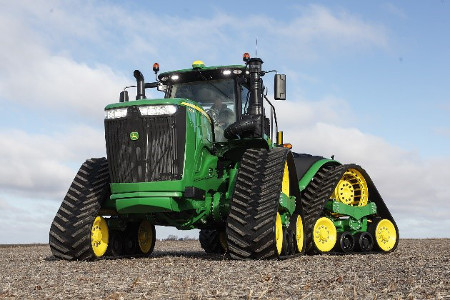 9RX with 91.4 cm (36 in.) tracks and 304.8-cm (120-in.) track spacing
9RX with 91.4 cm (36 in.) tracks and 304.8-cm (120-in.) track spacing
9RX Series Tractors with 304.8-cm (120-in.) track spacing increase space between the undercarriage and chassis to provide more space for performing daily and routine maintenance tasks.
 Performing daily maintenance tasks
Performing daily maintenance tasks
 Performing routine maintenance tasks
Performing routine maintenance tasks
| 9RX Series Tractors undercarriage configurations | ||||
 |
 |
|||
| Model | Narrow undercarriage | Wide undercarriage | ||
| Track spacing: 203.2 cm (80 in.), 223.5 cm (88 in.), or 304.8 cm (120 in.) |
Track spacing: 223.5 cm (88 in.) or 304.8 cm (120 in.) |
|||
| 45.7 cm (18 in.) tracks | 61 cm (24 in.) tracks | 76.2 cm (30 in.) tracks | 91.4 cm (36 in.) tracks | |
| 9420RX | • | • | --- | --- |
| 9470RX | • | • | • | • |
| 9520RX | • | • | • | • |
| 9570RX | --- | --- | • | • |
| 9620RX | --- | --- | • | • |
• Available
--- Not available
Features
PowerTech™ PSS cooled exhaust gas recirculation (EGR)
 PowerTech PSS 9.0L engine
PowerTech PSS 9.0L engine
The John Deere exhaust filter is integrated into the engine design and electronics to provide a seamless operator experience. The engine control unit (ECU) and exhaust temperature management (ETM) system work together to continuously regenerate the exhaust filter using a natural cleaning process sometimes referred to as passive regeneration.
If natural filter cleaning cannot be achieved based on temperature, load, and speed, then particulate matter (PM) must be removed using an automatic cleaning process sometimes referred to as active regeneration. In most cases, filter cleaning does not impact machine operation or require operator involvement. Higher pressures created by our Final Tier 4 (FT4)/Stage IV high-pressure fuel system extend intervals between automatic cleanings.
How EGR works
EGR reduces the high temperatures where nitrogen oxide (NOx) compounds are formed in the engine cylinders by replacing excess oxygen with a prescribed amount of cooled exhaust gas.
Exhaust gases contain more carbon dioxide than oxygen. The EGR valve, in conjunction with the venturi and ECU, allows a controlled amount of exhaust gas to enter the intake manifold to mix with the incoming fresh air. Replacing excess oxygen with cooled exhaust gas leads to lower combustion temperatures, creating less NOx. In addition, EGR allows for advanced timing, leading to optimal performance of the engine, maximizing fuel economy.
Flow of exhaust during engine operation
Exhaust airflow enters into the EGR cooler from the exhaust manifold near the turbocharger.
Based on engine load, air temperatures, and rpm, the ECU opens or closes the EGR valve, allowing a measured percentage of exhaust gas to enter the intake manifold.
The gases mix with the rest of the incoming air from the turbocharger and aftercooler before entering the cylinders.
The following diagrams illustrate how air flows through the engine (PSS).
For added performance and efficiency, the engine passes the exhaust gases through an EGR cooler before it enters the engine.
 PSS EGR
PSS EGR
PSS 9.0L and 13.5L FT4 technology
 PowerTech PSS Final Tier 4 technology
PowerTech PSS Final Tier 4 technology
Standard CommandView™ III cab offers unsurpassed amenities
 CommandView III cab
CommandView III cab
The standard CommandView III cab offers unsurpassed visibility, operator comfort, control placement, and ride and sound quality.
Features:
- ComfortCommand™ seat with air suspension, lumbar support, swivel, fore-aft and lateral attenuation, backrest angle adjustment, adjustable left-hand armrest, and 40-degree right-hand seat swivel
- Operator presence system that warns if the operator is out of the seat while operating key functions
- Folding instructional seat
- CommandARM™ control center with integrated controls
- 4100 or 4600 Generation 4 CommandCenter™ processor
- Behind-the-seat storage
- Left-hand storage compartment
- Passive noise reduction system
- Service ADVISOR™ diagnostic system data port
- Tilt/telescoping steering wheel with position memory
- Swing-out rear window, opens 30 degrees
- Right- and left-outside mirrors (manually adjustable mirror head)
- Monitor mounts on right-hand front post and rear cab post
- Standard radio package, including AM/FM stereo and weatherband with remote controls, auxiliary input jack, four speakers, and an external antenna
- Laminated glass
- Air conditioner and heater with automatic temperature controls (ATC)
- Two 12-V convenience outlet (cigarette lighter style)
- One 12-V 3-pin outlet with adapter (provides switched and unswitched power)
- One International Organization for Standardization (ISO) nine-pin connector
- Power strip with convenience plug adapter
- Hitch control lever lock and selective control lever lock
- Two-speed and intermittent front and rear wiper with washer
- Front pull-down sunshade
- Digital cornerpost display with:
- Fuel level gauge, including low fuel warning
- Temperature gauge
- Diesel exhaust fluid (DEF) gauge, including low DEF warning
- Engine rpm
- Transmission commanded gear or speed
- Vehicle system functions, such as iTEC™ end-row guidance, that are operating
- Inside-mounted rearview mirror
- Beverage holders sized to accommodate various containers
- Interior left-hand dome light
ComfortCommand seat
 ComfortCommand seat
ComfortCommand seat
ComfortCommand seat improves ride quality and helps to reduce operator fatigue
Features include:
- Armrests, lumbar support, and backrest angle are easily adjusted to match operator preference.
- Shock absorbers dampen the motion effect of the tractor for an improved ride.
- Seat height adjustments are conveniently located on the left armrest.
- Fore-aft adjustment is easy to reach located on the left front of the seat.
- Swivel adjustment, located on the front of the seat, allows the seat to be swiveled 40 degrees to the right or eight degrees to the left of the center position.
- Operator presence switch warns if the operator is out of the seat while operating key functions.
- Seat belt retractor.
- Centered cab seat, providing excellent over-shoulder visibility.
- Adjustable shock absorber permitting ride adjustment from soft to firm to match the operator's desired comfort level.
- Removable cushions for easy cleaning.
CommandARM
 CommandARM controls
CommandARM controls
John Deere 9 Family Tractors feature the CommandARM with integrated Generation 4 CommandCenter display. The control layout of the CommandARM utilizes a clean and efficient design which groups controls by function and builds upon John Deere’s history of intuitive and ergonomic control placement and operation. The design of the CommandARM allows for a 40-degree right seat swivel and adjustable positioning matching the operator’s preference.
Controls located on the CommandARM include:
- Engine throttle
- Transmission control for e18™ transmission speed PowerShift™ transmission
- Eco mode (minimum engine speed) for e18 speed PowerShift transmission
- FieldCruise™ engine controls
- Selective control valve (SCV) controls
- AutoLoad™ controls (if equipped)
- Differential lock on/off and automatic
- iTEC™ sequence switches
- AutoTrac™ assisted steering system resume switch (if equipped)
- Radio
- Beacon light on/off
- Hazard lights on/off
- Field lights 1/2
- Heating, ventilation, air-conditioning (HVAC) system
Hydraulic controls
Hydraulic controls utilize fingertip paddle pots for raise/lower and extend/retract functions.
 Fingertip paddle pots
Fingertip paddle pots
Throttle
The throttle design incorporates buttons which control FieldCruise speed, and transmission eco settings.
 Throttle
Throttle
Tractor function controls
Located just to the right of the throttle is the Auto-Trac activation button and four sequence controls for iTEC functions. Behind the iTEC sequence controls there are buttons which control the activation and deactivation of differential lock. Differential lock can also be activated by the foot switch on the cab floor.
 AutoTrac resume and iTEC strip
AutoTrac resume and iTEC strip
Controls for radio, lights, rotary beacon (if equipped), hazard flashers, and HVAC system are located to the center-right on the CommandARM, along with power take-off (PTO) for rear PTO.
 Radio, HVAC, hazard flashers, and PTO controls
Radio, HVAC, hazard flashers, and PTO controls
Seat swivel
The design of the CommandARM allows for up to 40 degrees of right-hand seat swivel.
 Seat swivel
Seat swivel
 40-degree seat swivel shown
40-degree seat swivel shown
CommandCenter
 Generation 4 CommandCenter
Generation 4 CommandCenter
The Generation 4 CommandCenters features fast adjustment of tractor functions and controls and are integrated into the CommandARM to create a seamless control center.
The following functions can be adjusted and accessed using the CommandCenter display:
- Hydraulic settings
- Hitch settings
- Transmission settings
- FieldCruise
- iTEC programming functions
- Radio
- Lights
- Add all functionality – diagnostics, display settings, etc.
The Generation 4 CommandCenter systems have the capability of Remote Display Access (RDA). RDA allows improved communication between an offsite farm manager or dealer and the equipment operator. The user can view exactly what the operator sees on the GreenStar™ 3 2630 Display and Generation 4 CommandCenter from almost any internet-connected device. RDA is available on the 4600 and 4100 CommandCenter and allows for an increase in productivity with quicker problem resolution. By using RDA, the cost of operation will decrease due to reduced labor and travel costs, and maximum efficiency will increase profit.
e18™ PowerShift™ transmission with Efficiency Manager™ feature
The e18 transmission delivers smooth shifting and intuitive controls in a reliable 18-speed PowerShift transmission. The e18 transmission with enhanced Efficiency Manager is standard equipment on all 9 Family Tractors.
The e18 has evolved from more than 50 years of John Deere PowerShift technology. With more automatic features, the e18 is easy to operate for all levels of operators and operations. It features three modes of operation, full AUTO, custom, and manual modes. Full AUTO and custom modes manage the engine and transmission to match the desired ground speed to the field conditions. These two modes are ideal for most conditions and take the guess work out of operation. Manual mode is perfect for operators looking to operate the e18 like a traditional PowerShift by bump shifting and managing the engine throttle to their liking.
As the next generation of PowerShift technology, the e18 delivers the strength to handle sudden, high-torque power loads while maintaining responsive, quick, and smooth shifts.
e18 controls
 Shift lever and hand throttle
Shift lever and hand throttle
CommandCenter™ controls
 254-mm (10-in.) Generation 4 CommandCenter
254-mm (10-in.) Generation 4 CommandCenter
The CommandCenter is the central information system for tractors and allows the operator to program various settings tailored to a specific operation.
To access the tractor’s transmission settings, press the transmission shortcut button on the CommandCenter shortcut bar.
 CommandCenter transmission shortcut button
CommandCenter transmission shortcut button
Operating modes
The e18 application settings employ three modes to take full advantage of the engine-transmission communication: Full AUTO mode, custom mode, and manual mode.
Full AUTO mode
 Full AUTO main page
Full AUTO main page
Full AUTO mode manages the tractor’s engine and transmission inputs to reach and maintain the desired ground speed set by the operator. This means the tractor will manage shifts and engine rpm to operate at the most efficient level possible. Operators have the ability to set the maximum forward and reverse speeds for their particular applications. In full AUTO mode the operator can adjust the desired ground speed in two ways, by conducting a traditional bump shift or by rotating the dial on the thumb wheel.
When shifting in full AUTO mode, the transmission shifts set speeds and does not always shift gears, meaning the transmission may not necessarily shift gears if it can reach the desired ground speed with a slightly higher or lower engine rpm. Efficiency Manager is automatically engaged while operating in full AUTO mode. As a result, shifting will not take the tractor out of Efficiency Manager in full AUTO mode.
Custom mode
 e18 custom transmission page
e18 custom transmission page
Custom mode operates similar to full AUTO mode but allows operators to adjust operating parameters to meet a specific operation. It also has the ability to activate eco mode for a higher level of operation.
 Eco button
Eco button
 Display screen
Display screen
Eco allows two minimum engine speeds to be set. Operators can turn eco on and off by either pushing the eco button on the side of the throttle or by selecting eco in the transmission settings page of the CommandCenter controls. For example, operators may choose to turn eco on during transport to utilize a lower minimum engine speed and then turn eco off while operating in the field where a higher minimum engine speed is desired.
 Custom settings page
Custom settings page
In the advanced settings page, operators can customize the auto shift engine speed droop as a percentage of the full engine speed. In addition, the load anticipation feature can be enabled for the hitch engagement, hydraulic engagement, or both.
Manual mode
Manual mode operates very similarly to a traditional PowerShift transmission with Efficiency Manager.
In manual mode the operator manages the engine and transmission inputs by controlling the shift lever and hand throttle.
 Manual mode page
Manual mode page
Efficiency Manager
 Set speed buttons and set speed adjuster
Set speed buttons and set speed adjuster
Efficiency Manager is automatically enabled in auto and custom modes. Efficiency Manager can be turned on in manual mode by selecting the set speed one or set speed two button on the CommandARM™ console. The set speed adjuster on the top of the single-lever gear selector allows the operator to dial in the desired ground speed to establish set speed one or two. Once engaged, Efficiency Manager will manage the engine rpm and gear selection to maintain the desired working speed. To reach the desired set speed, the throttle must be set to full engine rpm.
e18 operation
 e18 operation
e18 operation
Setting start-up gears
The 9 Family Tractors default to 7F and 2R at start up. However, these default start-up gears can be adjusted from 1-13F and 1-3R through the CommandCenter. Refer to the operator’s manual for additional information.
 Start-up gears in advanced settings
Start-up gears in advanced settings
9R Series Tractor - e18-speed chart for PowerShift transmission with Efficiency Manager
9R table
Group 47 tires |
Group 48 tires |
|||
Tire size |
(480R46, 20.8R42, 520R42, 620R42, 710R38) |
(480R50, 520R46, 620R46, 710R42, 800R38) |
||
Engine (rpm) |
2100 |
2100 |
||
18-speed gear |
km/h |
mph |
km/h |
mph |
Forward gears |
||||
F1 |
4.0 |
2.5 |
4.2 |
2.6 |
F2 |
4.8 |
3.0 |
5.0 |
3.1 |
F3 |
5.3 |
3.3 |
5.6 |
3.5 |
F4 |
5.9 |
3.7 |
6.2 |
3.9 |
F5 |
6.5 |
4.0 |
6.8 |
4.3 |
F6 |
7.3 |
4.5 |
7.6 |
4.8 |
F7 |
8.0 |
5.0 |
8.5 |
5.3 |
F8 |
9.0 |
5.6 |
9.5 |
5.9 |
F9 |
9.9 |
6.1 |
10.4 |
6.5 |
F10 |
11.0 |
6.9 |
11.6 |
7.2 |
F11 |
12.2 |
7.6 |
12.9 |
8.0 |
F12 |
13.5 |
8.4 |
14.2 |
8.8 |
F13 |
15.0 |
9.3 |
15.8 |
9.8 |
F14 |
16.6 |
10.3 |
17.5 |
10.9 |
F15 |
20.5 |
12.8 |
21.6 |
13.4 |
F16 |
25.3 |
15.7 |
26.6 |
16.5 |
F17 |
31.2 |
19.4 |
32.9 |
20.4 |
F18 |
38.5 |
23.9 |
40.5 |
25.2 |
Reverse gears |
||||
R1 |
3.9 |
2.4 |
4.1 |
2.5 |
R2 |
5.3 |
3.3 |
5.6 |
3.5 |
R3 |
5.9 |
3.7 |
6.2 |
3.9 |
R4 |
8.0 |
5.0 |
8.5 |
5.3 |
R5 |
9.0 |
5.6 |
9.5 |
5.9 |
R6 |
12.2 |
7.6 |
12.9 |
8.0 |
Group 47 tire based on 710/70R38
Group 48 tire based on 800/80R38
9RT and 9RX Series Tractor - e18-speed chart for PowerShift transmission with Efficiency Manager
9RT and 9RX table
|
9RT |
9RX |
||
Engine (rpm) |
2100 |
2100 |
||
18-speed gear |
km/h |
mph |
km/h |
mph |
Forward gears |
|
|
|
|
F1 |
4.0 |
2.5 |
4.0 |
2.5 |
F2 |
5.0 |
3.1 |
4.9 |
3.0 |
F3 |
5.5 |
3.4 |
5.5 |
3.4 |
F4 |
6.1 |
3.8 |
6.1 |
3.8 |
F5 |
6.8 |
4.2 |
6.7 |
4.2 |
F6 |
7.6 |
4.7 |
7.5 |
4.7 |
F7 |
8.4 |
5.2 |
8.3 |
5.2 |
F8 |
9.3 |
5.8 |
9.2 |
5.7 |
F9 |
10.3 |
6.4 |
10.2 |
6.3 |
F10 |
11.4 |
7.1 |
11.4 |
7.1 |
F11 |
12.6 |
7.8 |
12.6 |
7.8 |
F12 |
14.1 |
8.7 |
14.0 |
8.7 |
F13 |
15.6 |
9.7 |
15.5 |
9.6 |
F14 |
17.3 |
10.7 |
17.2 |
10.3 |
F15 |
21.4 |
13.3 |
21.3 |
13.2 |
F16 |
26.3 |
16.3 |
26.2 |
16.3 |
F17 |
32.3 |
20.1 |
32.2 |
20.0 |
F18 |
39.8 |
24.7 |
39.6 |
24.6 |
Reverse gears |
|
|
|
|
R1 |
4.0 |
2.5 |
4.0 |
2.5 |
R2 |
5.5 |
3.4 |
5.5 |
3.4 |
R3 |
6.1 |
3.3 |
6.1 |
3.8 |
R4 |
7.3 |
3.8 |
8.3 |
5.2 |
R5 |
9.3 |
5.8 |
9.2 |
5.7 |
R6 |
12.6 |
7.8 |
12.6 |
10.3 |
JDLink™ services and Service ADVISOR™ diagnostic systems
JDLink
 JDLink Dashboard
JDLink Dashboard
JDLink is the John Deere telematics system designed for operators and managers who desire to take their operations to the next level of productivity and efficiency without leaving the office. Whether it is receiving an e-mail or text message, users can manage the operation in real-time without being in the cab. Using the power of JDLink can optimize productivity, increase uptime, and boost profits with JDLink information all accessible from a laptop, desktop, or mobile device.
JDLink Ultimate provides enhanced machine performance and utilization information that can only be achieved through direct communication with on-board machine controllers. Utilizing John Deere-exclusive telematics technology, users can remotely link to Ultimate-compatible machines to achieve a new level of optimization.
NOTE: Mobile device compatibility and functionality varies.
Monitor assets, performance, and more with JDLink:
- Increase uptime and reduce time spent managing equipment with JDLink Ultimate
- Coordinate machine and labor logistics
- Unleash new possibilities with wireless machine connectivity
- Locate machines on-the-go with the JDLink app for iPhone®, iPad® or Android™ devices
- Leverage common components from the JDLink system to enable remote support and machine monitoring
- Industry-exclusive Service ADVISOR Remote with JDLink (Canada link)
For more information on JDLink activations and subscriptions, visit www.StellarSupport.com.
NOTE: JDLink is not available in all geographic regions.
Service ADVISOR
 Service ADVISOR
Service ADVISOR
Service ADVISOR diagnostics greatly assist in reducing service costs and downtime. It allows the John Deere service technician to readily extract vital information about tractor malfunctions through the Service ADVISOR data port. Diagnostic codes and controller area network (CAN) bus statistics stored by the tractor and visible in the CommandCenter™ display are used by service technicians to isolate, identify, and resolve problems.
Diagnostics and CAN bus statistics are not normally used by the operator. Access and use of trouble codes should only be done by a qualified, factory-trained John Deere service technician.
Service ADVISOR Remote
Service ADVISOR Remote takes the machine connectivity of JDLink and takes it one step further. With Service ADVISOR Remote, machines can be diagnosed remotely, saving the cost of a field service call. For example, diagnostic trouble codes can be reset and software updates can be uploaded remotely.
Apple, iPhone, and iPad are trademarks of Apple Inc. Android is a trademark of Google LLC.
High-flow hydraulics, 435-L/min (115-gpm) system
Dual hydraulic pump system
 Selective control valve (SCV) stack
Selective control valve (SCV) stack
Optional high-flow hydraulics are available on 9 Family Tractors by ordering code 3270. The high-flow hydraulic system provides an additional 215 L/min (57 gpm) of flow for a total of 435 L/min (115 gpm). This system is ideal for hydraulic fan motor demands. This system is recommended for agricultural implements with continuous flow requirements. When maximum hydraulic pump capacity is reached, multiple functions will continue to operate at the same proportional flow rate.
The 9 Family Ag High-Flow Tractors have two parallel hydraulic systems. The benefit of this system is that functions can be split between the two systems. Functions that require high flow and low pressure can be combined on one system (for example, air seeder fans, and planter motors). Functions that require high pressure and low-flow can be connected to the remaining system (for example, implement lift, fold, and constant down-pressure systems).
Following these guidelines allows the hydraulic system to run cooler as it prevents both hydraulic pumps from running at high pressure. In general, pumps forced to run at both high pressure and high flows generate much more heat than a pump running at a lower flow or lower pressure.
The system operates with two hydraulic pumps:
- Pump 1 - provides hydraulic flow of up to 215 L/min (58 gpm) to SCVs 1, 2, and 3. These SCVs are useful for operating lift/lower and other cylinder type hydraulic needs.
- Pump 2 - attaches in front of pump 1 and provides hydraulic flow of up to 215 L/min (57 gpm) to SCVs 4, 5, and 6. These SCVs are useful for operating hydraulic motors to drive air/fan or vacuum systems on seeding/planting equipment.
- All SCV oil returns to one common hydraulic reservoir.
Eight-section SCV stack for high-flow requirements
 Five 1.3-cm (1/2-in.) couplers (A) and three 1.9-cm (3/4-in.) couplers (B)
Five 1.3-cm (1/2-in.) couplers (A) and three 1.9-cm (3/4-in.) couplers (B)
For applications requiring continuous high hydraulic flow or multiple 1.9-cm (3/4-in.) hydraulic connections, this SCV stack is designed to maximize efficiency of the hydraulic system while providing additional flow using 1.9-cm (3/4-in.) couplers. Arrangement of the 1.9-cm (3/4-in.) couplers are split between the tractor’s dual hydraulic pumps to even the hydraulic load on each pump. Increasing coupler size from 1.3 cm (1/2 in.) to 1.9 cm (3/4 in.) allows an additional 26.5 L/min (7 gpm) or 17 percent more hydraulic flow through each coupler and reduces backpressure for hydraulic functions such as dual fan motors associated with the Air Power™ 2 system equipped on John Deere C850 Air Carts. With three 1.9-cm (3/4-in.) couplers available, operators can connect to other high-demand functions such as raise/lower. The 1.9-cm (3/4-in.) couplers also allow higher fan motor speeds for high-rate applications and allow more power to the ground due to less restriction on the hydraulic system.
NOTE: This SCV configuration is available on all double-reduction) axle 9420R to 9570R Tractors with high-flow hydraulics and all 9RX Tractors with high-flow hydraulics. This eight-section SCV stack does not include hydraulic Intelligent Power Management (IPM) software.
 SCV couplers
SCV couplers
Connections to 1.3-cm (1/2-in.) and 1.9-cm (3/4-in.) couplers are quick and simple for operators with a split SCV stack configuration at a comfortable connection height.
 SCV connections in a stack configuration
SCV connections in a stack configuration
General maintenance
 9R, 9RT, and 9RX service access
9R, 9RT, and 9RX service access
Regular service and maintenance are essential to the performance, productivity, and longevity of all farm machinery.
Maximum uptime is an important element of productivity.
- 9 Family service points are quick and simple to check.
- Greater accessibility improves serviceability.
All items in the daily service schedule can be performed without the use of tools:
- Engine oil, hydraulic oil, coolant level, and water separator can be conveniently accessed from ground level without having to open the hood. Engine oil can be checked by simply removing one small engine side panel.
 Engine oil service point
Engine oil service point
- Engine can be easily accessed by simply raising the one-piece hood and removing two engine side panels for more periodic maintenance checks.
- Single-point latch mechanism ensures easy hood opening and closure.
NOTE: Always refer to the operator’s manual for complete maintenance and service recommendations.
Refueling
 Fuel tank on the 9R
Fuel tank on the 9R
 Refueling
Refueling
The 9R Series Tractors fuel tank is located over the rear axle. The fuel tank features a dual fill design. This design allows the machine to be filled from either side of the fuel tank. A fuel nozzle holder is located when the operator positions themselves on the gudgeon platform to fill the fuel tank.
The diesel exhaust fluid (DEF) tank is located on the left-hand side of the tractor indicated by a blue cap. It is fillable from ground level and has a protective shield to keep debris out of the fill neck.
Model |
Diesel |
DEF |
9370R |
1211 L (320 gal.) | 120 L (31.7 gal.) |
9420R |
1514 L (400 gal.)* | 120 L (31.7 gal.) |
9470R |
1514 L (400 gal.)* | 120 L (31.7 gal.) |
9520R |
1514 L (400 gal.) | 120 L (31.7 gal.) |
9570R |
1514 L (400 gal.) | 120 L (31.7 gal.) |
9620R |
1514 L (400 gal.) | 120 L (31.7 gal.) |
*When equipped with double-reduction axle. 1211-L (320-gal.) when equipped with single-reduction axle.
 Fuel tank on the left side of 9RT
Fuel tank on the left side of 9RT
The 9RT fuel tank is located behind the cab; the fuel fill is located conveniently on the left-hand main platform.
The 9RT Series Tractors all feature a DEF tank capacity of 93.9 L (24.8 gal.). The fill location is near the diesel fill location.
Model |
Diesel |
DEF |
9470RT |
1325 L (350 gal.) | 93.9 L (24.8 gal.) |
9520RT |
1325 L (350 gal.) | 93.9 L (24.8 gal.) |
9570RT |
1325 L (350 gal.) | 93.9 L (24.8 gal.) |
Model |
Diesel |
DEF |
9470RX |
1514 L (400 gal.) | 120 L (31.7 gal.) |
9520RX |
1514 L (400 gal.) | 120 L (31.7 gal.) |
9570RX |
1514 L (400 gal.) | 120 L (31.7 gal.) |
9620RX |
1514 L (400 gal.) | 120 L (31.7 gal.) |
NOTE:
- John Deere supports the usage of bio diesel. Bio diesel should meet ASTM D6751 (US) or EN 14214 (European) fuel quality standards.
- Tractors receive fuel containing a 2 percent bio-diesel blend at the factory.
- Acceptable blend levels may vary by geographic region.
- Diesel exhaust fluid will freeze when exposed for longer than three hours to conditions below -11°C (12.2° F).
For more information about the use of bio-diesel in John Deere engines, refer to www.JohnDeere.com/biodiesel.
DEF fill
9R, 9RT, and 9RX Series Tractors feature an easy-to-use DEF fill system. The 9R and 9RX feature a ground-level fill location, and DEF fill on 9RT is conveniently located on the step platform.
| Machine | DEF tank capacity |
| 9R | 120 L (31.7 gal.) |
| 9RT | 93.9 L (24.8 gal.) |
| 9RX | 120 L (31.7 gal.) |
 DEF tank on 9R/9RX
DEF tank on 9R/9RX
In-line DEF filter
9R, 9RT, and 9RX Series Tractors feature an in-line DEF filter to help protect the DEF pump from any contamination in the DEF tank. This in-line DEF filter is easily serviced with a drain plug to drain any remaining DEF from the filter housing and a replaceable cartridge-style filter.
 In-line DEF filter
In-line DEF filter
Severe-duty water separator, if equipped
The severe-duty water separator can extend service intervals and helps to protect the tractor’s fuel system from damage associated with lower-quality fuel.
Simply open the drain valve on the bottom of the separator and drain accumulated water.
NOTE: Cummins® QSX 15 L (915.4-cu in.) engines cannot be equipped with a severe-duty water separator; however, the fuel filter has separating capabilities like the primary filter on John Deere Power System engines.
Engine access
 Engine access on 9RX
Engine access on 9RX
The tilt hood and side panel design provides additional engine compartment protection. The 9R, 9RT, and 9RX hoods feature the same design for access to engine components.
Pull out the hood release (located on the front, left side) and tilt hood back to open. Engine side panels are quickly and easily removed for access to periodic maintenance items.
 Removing side engine panel
Removing side engine panel
Transmission, hydraulic, and axle oil level
 Sight gauge on 9R and 9RX
Sight gauge on 9R and 9RX
 Sight gauge on 9RT
Sight gauge on 9RT
A sight glass for the transmission, hydraulic, and axle oil level is located at the back right side of the gudgeon, indicating proper oil levels, and an oil fill neck is located on the back right side of the gudgeon for the 9R and 9RX Series Tractor. The oil fill is located on the top of the common reservoir on the left side of the 9RT Series Tractor and a fill tube is located between the steps and engine of the tractor.
- Provides increased filter capacity compared to previous 9R and 9RT Series Tractors
- Transmission, hydraulic, and axle oil should be changed every 1500 hours
- Filter should be changed every 1500 hours unless filter restriction code occurs
- Daily and 10-hour inspections of the transmission hydraulic oil level are recommended
NOTE: The tractor should be off and parked on level ground with the hitch in the lowered position when checking the oil level.
- Sight glass observations will be significantly higher with hot oil temperatures and lower with cold oil or if engine has not run long enough.
NOTE: Oil level above the top mark on the sight glass can result in power loss and heat generation during transport applications.
Primary air filter access
 Primary engine air filter inspection
Primary engine air filter inspection
On the 9R and 9RX, the primary engine air filter is accessible from the left-hand platform for replacement annually or as operating conditions require. The filter is aspirated and extends filter life in dusty conditions by aspirating more than 95 percent of incoming dust. Aspirator suction is created by utilizing the air flow from the cooling fan.
On the 9RT, the primary engine air filter is located at ground level on right side of tractor.
Oil change intervals
 Engine oil check/fill location
Engine oil check/fill location
Tractors with the 9.0L (549.2-cu in.) and 13.5L (823.2-cu in.) John Deere Power Systems engines feature a 500-hour change interval when using approved John Deere Plus-50™ II oil and a John Deere oil filter.
Tractors equipped with the Cummins QSX 15-L (915.4-cu in.) engine have a 400-hour engine oil and oil filter change interval.
- Previous initial oil and filter change at 100 hours is no longer required due to the factory fill of Break-In™ Plus oil.
- If using anything other than John Deere Plus-50 II oil, a 250-hour change interval is required. CJ-4 must still be used.
- Only use ultra-low sulfur diesel fuel and CJ-4, ACEA E9, or ACEA E6 oil.
- An oil change of 500 hours is possible when using fuel with less than 15 parts per million (ppm) of sulfur, along with John Deere Plus-50 II oil.
See the tractor's operator's manual for oil change intervals and further details.
Battery access
 Battery location on 9R and 9RX
Battery location on 9R and 9RX
 Battery location on 9RT
Battery location on 9RT
The 9R and 9RX battery location is behind the left-hand step assembly. There are three bolts that secure the swinging step assembly that need to be removed to completely access the batteries. The 9RT top step of the platform conceals the tractor’s three 12-V batteries with 2775 CCA (925-CCA each). Tractors with the Cummins X15 engine will have four 12-V batteries in the same location as tractors equipped with John Deere Power System engines.
Although the batteries are maintenance free, conditions such as long periods of operation at high ambient temperatures and excessive engine cranking may require adding water.
Battery boost terminal
 Battery boost terminal
Battery boost terminal
On the 9R and 9RX, a battery boost terminal is located on the left-hand side of the engine for convenient and proper boost assisted starting.
Fuse and relay panel
 Fuse and relay panel
Fuse and relay panel
The electrical fuse and relay panel is located behind the operator’s seat and just below the cab's rear window. Simply lift up on the operator manual cover for access.
- Contains easy-to-replace automotive blade-type fuses and relays for quick servicing.
- Spare fuses are provided for each amperage size used.
The diode module contains many of the diodes contained in the system:
- If a diode problem occurs, simply replace the diode module for easy service and increased uptime.
- Relays are also fully interchangeable for quick service.
Electrical system (smart load center)
The electrical system provides a full controller area network (CAN) bus based system on the tractor for improved tractor implement integration and flexibility. Incorporated with the system is a smart load center, which provides fewer fuses, fewer connectors, and simplified wiring for increased reliability.
The solid-state load center’s primary function is to control the majority of high-current loads, such as fender floodlights and the horn. This electronic circuitry will monitor loads and voltages to provide fast reaction time and the ability to alert the operator if a circuit overloads or if voltage is out of specification – for example, open circuit (undercurrent) or short circuit (overcurrent).
Cab air filters
 Cab fresh air filter inspection
Cab fresh air filter inspection
 Cab recirculation filter
Cab recirculation filter
The cab fresh air filter is conveniently located beneath the left side of the cab for all 9 Family products:
- External service means no mess in the cab from dusty filters
- Filter housing acts as a dust accumulator compartment
- Hand screw eliminates need for tools
- Replace cab fresh air filter every 1000 hours or sooner if plugged or damaged
Cab air recirculation filter
Cab air recirculation filter is located in the roof liner above the operator. 70 percent of the total air volume is recirculated with a blanket effect for enhanced operator comfort.
- Replace cab air recirculation filter every 1000 hours or sooner if plugged or damaged.
Cab air filters are not designed to filter out harmful chemicals. Follow the instructions in the implement operator’s manual and those given by the chemical manufacturer when using agricultural chemicals.
Windshield washer
 Windshield washer bottle on 9R and 9RX
Windshield washer bottle on 9R and 9RX
The windshield washer bottle is optional on 9R and 9RX Tractors and is located on the left side of the tractor near the DEF fill point. On 9RT Tractors, it is located on the right-side frame.
Maintenance-free U-joint
Maintenance-free U-joint bearings require no servicing to reduce maintenance time.
Toolbox
 Toolbox for 9R, 9RT and 9RX
Toolbox for 9R, 9RT and 9RX
A convenient toolbox is located on the left-hand side of the front frame for tool storage and comes standard on all 9R, 9RT, and 9RX Series Tractors.
9R and 9RX Series Tractors have an additional storage box conveniently located on top the left-hand platform.
The 9RT has an additional toolbox conveniently located next to the left side of the batteries for additional storage.
Cummins is a trademark of Cummins, Inc.
Tow cable attachment
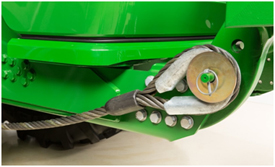 Tow cable front hook
Tow cable front hook
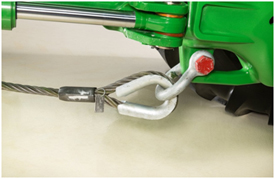 Rear tow cable connection point
Rear tow cable connection point
The front tow cable is recommended for pulling all 9 Family Tractors in time of needed assistance. Tow cables are available as a factory-installed option on all ag tractors and are base equipment on all Scraper Special Tractors. The tow cable attaches to the area in front of the drawbar and is also available as a field-installed option.
9RX Tractor narrow undercarriage recommended transport speed
9RX Series Tractors equipped with 45.7-cm (18-in.) and 61-cm (24-in.) tracks feature a maximum speed of 42 km/h (26 mph).
9RX Series Tractors equipped with 45.7-cm (18-in.) or 61-cm (24-in.) tracks are advised to reduce ground speed based on axle load. 9RX Series Tractors equipped with 45.7-cm (18-in.) tracks will have a top speed set at the factory of 31 km/h (19 mph). Maximum speed may be adjusted up to 42 km/h (26 mph) upon review of the transport speed recommendations in the Operator’s Manual.
The speed reduction allows the undercarriage components and tracks to dissipate heat buildup caused by the higher axle loads, reducing undercarriage component and track damage. Increasing mid-roller surface area will increase the undercarriage ability to dissipate heat.
Narrow undercarriage with 45.7-cm (18-in.) tracks feature a narrower mid-roller matched to track width. This results in a smaller mid-roller surface area than 61-cm (24-in.) tracks, which are also matched to track width.
Producers who desire a 9RX machine for row-crop work and who also transport long distances with high axle loads should understand the limitations of the 45.7-cm (18-in.) and 61-cm (24-in.) tracks. 61-cm (24-in.) tracks with a greater mid-roller surface area will provide greater undercarriage and machine performance in transport while maintaining the ability to perform row-crop work. Comparing the transport speed recommendations for 45.7-cm (18-in.) and 61-cm (24-in.) tracks, the speed reduction is higher for 45.7-cm (18-in.) tracks for the same axle load.
9RX Series Tractors with a wide undercarriage and 76.2-cm (30-in.) or 91.4-cm (36-in.) tracks do not feature a speed reduction with increased axle load.
 9RX in transport
9RX in transport
9RX Series Tractor owners and operators need to be aware of axle loads and the recommended speed. The operator’s manual for both the machine and implement will have information on advised transport speeds. 9RX Series Tractors equipped with narrow undercarriage will also feature an in-cab window decal and reference card stored in the armrest for quick guidance on recommended transport speed based on axle load. Many implements may have a lower recommended transport speed than the tractor,; it is always advised to follow the lowest recommended transport speed.
 Maximum transport speed with axle weight
Maximum transport speed with axle weight
Window decal
| Window decal | |||||
| Single axle weight | 18 inch track max. | 24 inch track max. | |||
| (kg) | (lbs) | km/h | mph | km/h | mph |
| Tractor | 42 | 26 | 42 | 26 | |
| 15,900 | 35,000 | 34 | 21 | 42 | 26 |
| 20,400 | 45,000 | 26 | 16 | 37 | 23 |
| 24,900 | 55,000 | 21 | 13 | 32 | 20 |
Speed increments
| 1 mph increment | |||||||
| Single axle weight | 18 inch track max. | Single axle weight | 24 inch track max. | ||||
| (kg) | (lbs) | km/h | mph | (kg) | (lbs) | km/h | mph |
| 14,500 | 32,000 | 42 | 26 | 16,800 | 37,000 | 42 | 26 |
| 15,000 | 33,000 | 37 | 23 | 18,100 | 40,000 | 40 | 25 |
| 15,400 | 34,000 | 35 | 22 | 19,500 | 43,000 | 39 | 24 |
| 15,900 | 35,000 | 34 | 21 | 20,900 | 46,000 | 37 | 23 |
| 16,300 | 36,000 | 32 | 20 | 22,200 | 49,000 | 35 | 22 |
| 17,200 | 38,000 | 31 | 19 | 23,600 | 52,000 | 34 | 21 |
| 18,100 | 40,000 | 29 | 18 | 24,900 | 55,000 | 32 | 20 |
| 19,500 | 43,000 | 27 | 17 | 27,200 | 60,000 | 31 | 19 |
| 20,900 | 46,000 | 26 | 16 | ||||
| 22,200 | 49,000 | 24 | 15 | ||||
| 23,600 | 52,000 | 23 | 14 | ||||
| 25,400 | 56,000 | 21 | 13 | ||||
| 27,200 | 60,000 | 19 | 12 | ||||
Implement speed recommendations
| Application | Implement | Payload | Total tractor | Rear axle load (lbs) | Front axle load (lbs) | 18 inch (mph) | 24 inch (mph) |
| Other | 60' 2410C applicator | 400 | 61,400 | 30,000 | 32,000 | 26 | 26 |
| Primary Tillage | 9 shank 2720 (without rolling baskets) | 500 | 61,500 | 30,000 | 32,000 | 26 | 26 |
| Primary Tillage | 11 shank 2730 (gangs, without rolling baskets) | 484 | 61,484 | 30,000 | 32,000 | 26 | 26 |
| Secondary Tillage | 45' 2210LL cultivator | 1100 | 62,100 | 31,000 | 31,000 | 26 | 26 |
| Secondary Tillage | 40' 2623 VT | 1800 | 62,800 | 32,000 | 31,000 | 26 | 26 |
| Other | 60' 2510L 2400 gal (empty) | 3608 | 64,608 | 34,000 | 30,000 | 22 | 26 |
| Other | 1100 bu grain cart empty (Kinze 1100) | 3950 | 64,950 | 35,000 | 30,000 | 21 | 26 |
| Secondary Tillage | 45' 2310 mulch finisher | 4200 | 65,200 | 35,000 | 30,000 | 21 | 26 |
| Other | 1500 bu grain cart empty (Brent Avalanche 1596) | 3800 | 64,800 | 35,000 | 30,000 | 21 | 26 |
| Other | 1000 bu grain cart loaded (Brent 1082) | 4710 | 65,710 | 36,000 | 30,000 | 20 | 26 |
| Other | 1500 bu grain cart empty (Kinze 1500) | 5250 | 66,250 | 37,000 | 30,000 | 19 | 26 |
| Other | 1500 bu grain cart empty (Brent Avalanche 1596) | 5500 | 66,50 | 37,000 | 30,000 | 19 | 26 |
| Other | 1100 bu grain cart loaded (Kinze 1100) | 6280 | 67,280 | 38,000 | 29,000 | 19 | 25 |
| Other | 1100 bu grain cart loaded (Kinze 1500) | 7380 | 68,380 | 39,000 | 29,000 | 18 | 25 |
| Planters | DB60 47R15 CCS | 8340 | 69,340 | 41,000 | 29,000 | 17 | 24 |
| Planters | DB90 Planter | 12,300 | 73,300 | 46,000 | 27,000 | 16 | 23 |
| Planters | 1775NT 24R drawbar (need to verify) | 13,000 | 74,000 | 47,000 | 27,000 | 15 | 22 |
| Planters | DB120 Planter | 17,600 | 78,600 | 54,000 | 25,000 | 13 | 20 |
| Other | Hitch load | 15,000 | 76,000 | 54,000 | 22,000 | 13 | 20 |
NOTE: Example implements are for reference and direction only. Weigh the tractor and the amount of weight on the axle to determine the final recommended speed. Weights of implements will vary due to different configurations available between tractor and implement. Never exceed the maximum speed recommendation of any implement.
For producers who wish to limit vehicle top speed, transmission settings can be adjusted on the CommandARM™ display or user profiles can be established which locks out the ability to change vehicle top speed by the operator unless they enter the PIN.
9RX 304.8-cm (120-in.) track spacing options
Beginning with model year 2019 production, 9RX Series Tractors equipped with 76.2-cm (30-in.) and 91.4-cm (36-in.) tracks can be equipped with industry-exclusive, factory-installed track spacing set at 304.8-cm (120-in.).
9RX Series Tractors equipped with 304.8-cm (120-in.) track spacing provide increased stability, allow producers to operate on 304.8-cm (120-in.) centers for controlled traffic farming, and provide improved track-to-frame clearance for better access to the undercarriage for serviceability and material cleanout. John Deere is the first and only tractor manufacturer to offer a 304.8-cm (120-in.) track spacing option on four-track tractors with 76.2-cm (30-in.) and 91.4-cm (36-in.) tracks up to 462.3 kW (620 hp).
 9RX with 91.4 cm (36 in.) tracks and 304.8-cm (120-in.) track spacing
9RX with 91.4 cm (36 in.) tracks and 304.8-cm (120-in.) track spacing
9RX Series Tractors with 304.8-cm (120-in.) track spacing increase space between the undercarriage and chassis to provide more space for performing daily and routine maintenance tasks.
 Performing daily maintenance tasks
Performing daily maintenance tasks
 Performing routine maintenance tasks
Performing routine maintenance tasks
| 9RX Series Tractors undercarriage configurations | ||||
 |
 |
|||
| Model | Narrow undercarriage | Wide undercarriage | ||
| Track spacing: 203.2 cm (80 in.), 223.5 cm (88 in.), or 304.8 cm (120 in.) |
Track spacing: 223.5 cm (88 in.) or 304.8 cm (120 in.) |
|||
| 45.7 cm (18 in.) tracks | 61 cm (24 in.) tracks | 76.2 cm (30 in.) tracks | 91.4 cm (36 in.) tracks | |
| 9420RX | • | • | --- | --- |
| 9470RX | • | • | • | • |
| 9520RX | • | • | • | • |
| 9570RX | --- | --- | • | • |
| 9620RX | --- | --- | • | • |
• Available
--- Not available
Features
PowerTech™ PSS cooled exhaust gas recirculation (EGR)
 PowerTech PSS 9.0L engine
PowerTech PSS 9.0L engine
The John Deere exhaust filter is integrated into the engine design and electronics to provide a seamless operator experience. The engine control unit (ECU) and exhaust temperature management (ETM) system work together to continuously regenerate the exhaust filter using a natural cleaning process sometimes referred to as passive regeneration.
If natural filter cleaning cannot be achieved based on temperature, load, and speed, then particulate matter (PM) must be removed using an automatic cleaning process sometimes referred to as active regeneration. In most cases, filter cleaning does not impact machine operation or require operator involvement. Higher pressures created by our Final Tier 4 (FT4)/Stage IV high-pressure fuel system extend intervals between automatic cleanings.
How EGR works
EGR reduces the high temperatures where nitrogen oxide (NOx) compounds are formed in the engine cylinders by replacing excess oxygen with a prescribed amount of cooled exhaust gas.
Exhaust gases contain more carbon dioxide than oxygen. The EGR valve, in conjunction with the venturi and ECU, allows a controlled amount of exhaust gas to enter the intake manifold to mix with the incoming fresh air. Replacing excess oxygen with cooled exhaust gas leads to lower combustion temperatures, creating less NOx. In addition, EGR allows for advanced timing, leading to optimal performance of the engine, maximizing fuel economy.
Flow of exhaust during engine operation
Exhaust airflow enters into the EGR cooler from the exhaust manifold near the turbocharger.
Based on engine load, air temperatures, and rpm, the ECU opens or closes the EGR valve, allowing a measured percentage of exhaust gas to enter the intake manifold.
The gases mix with the rest of the incoming air from the turbocharger and aftercooler before entering the cylinders.
The following diagrams illustrate how air flows through the engine (PSS).
For added performance and efficiency, the engine passes the exhaust gases through an EGR cooler before it enters the engine.
 PSS EGR
PSS EGR
PSS 9.0L and 13.5L FT4 technology
 PowerTech PSS Final Tier 4 technology
PowerTech PSS Final Tier 4 technology
Standard CommandView™ III cab offers unsurpassed amenities
 CommandView III cab
CommandView III cab
The standard CommandView III cab offers unsurpassed visibility, operator comfort, control placement, and ride and sound quality.
Features:
- ComfortCommand™ seat with air suspension, lumbar support, swivel, fore-aft and lateral attenuation, backrest angle adjustment, adjustable left-hand armrest, and 40-degree right-hand seat swivel
- Operator presence system that warns if the operator is out of the seat while operating key functions
- Folding instructional seat
- CommandARM™ control center with integrated controls
- 4100 or 4600 Generation 4 CommandCenter™ processor
- Behind-the-seat storage
- Left-hand storage compartment
- Passive noise reduction system
- Service ADVISOR™ diagnostic system data port
- Tilt/telescoping steering wheel with position memory
- Swing-out rear window, opens 30 degrees
- Right- and left-outside mirrors (manually adjustable mirror head)
- Monitor mounts on right-hand front post and rear cab post
- Standard radio package, including AM/FM stereo and weatherband with remote controls, auxiliary input jack, four speakers, and an external antenna
- Laminated glass
- Air conditioner and heater with automatic temperature controls (ATC)
- Two 12-V convenience outlet (cigarette lighter style)
- One 12-V 3-pin outlet with adapter (provides switched and unswitched power)
- One International Organization for Standardization (ISO) nine-pin connector
- Power strip with convenience plug adapter
- Hitch control lever lock and selective control lever lock
- Two-speed and intermittent front and rear wiper with washer
- Front pull-down sunshade
- Digital cornerpost display with:
- Fuel level gauge, including low fuel warning
- Temperature gauge
- Diesel exhaust fluid (DEF) gauge, including low DEF warning
- Engine rpm
- Transmission commanded gear or speed
- Vehicle system functions, such as iTEC™ end-row guidance, that are operating
- Inside-mounted rearview mirror
- Beverage holders sized to accommodate various containers
- Interior left-hand dome light
ComfortCommand seat
 ComfortCommand seat
ComfortCommand seat
ComfortCommand seat improves ride quality and helps to reduce operator fatigue
Features include:
- Armrests, lumbar support, and backrest angle are easily adjusted to match operator preference.
- Shock absorbers dampen the motion effect of the tractor for an improved ride.
- Seat height adjustments are conveniently located on the left armrest.
- Fore-aft adjustment is easy to reach located on the left front of the seat.
- Swivel adjustment, located on the front of the seat, allows the seat to be swiveled 40 degrees to the right or eight degrees to the left of the center position.
- Operator presence switch warns if the operator is out of the seat while operating key functions.
- Seat belt retractor.
- Centered cab seat, providing excellent over-shoulder visibility.
- Adjustable shock absorber permitting ride adjustment from soft to firm to match the operator's desired comfort level.
- Removable cushions for easy cleaning.
CommandARM
 CommandARM controls
CommandARM controls
John Deere 9 Family Tractors feature the CommandARM with integrated Generation 4 CommandCenter display. The control layout of the CommandARM utilizes a clean and efficient design which groups controls by function and builds upon John Deere’s history of intuitive and ergonomic control placement and operation. The design of the CommandARM allows for a 40-degree right seat swivel and adjustable positioning matching the operator’s preference.
Controls located on the CommandARM include:
- Engine throttle
- Transmission control for e18™ transmission speed PowerShift™ transmission
- Eco mode (minimum engine speed) for e18 speed PowerShift transmission
- FieldCruise™ engine controls
- Selective control valve (SCV) controls
- AutoLoad™ controls (if equipped)
- Differential lock on/off and automatic
- iTEC™ sequence switches
- AutoTrac™ assisted steering system resume switch (if equipped)
- Radio
- Beacon light on/off
- Hazard lights on/off
- Field lights 1/2
- Heating, ventilation, air-conditioning (HVAC) system
Hydraulic controls
Hydraulic controls utilize fingertip paddle pots for raise/lower and extend/retract functions.
 Fingertip paddle pots
Fingertip paddle pots
Throttle
The throttle design incorporates buttons which control FieldCruise speed, and transmission eco settings.
 Throttle
Throttle
Tractor function controls
Located just to the right of the throttle is the Auto-Trac activation button and four sequence controls for iTEC functions. Behind the iTEC sequence controls there are buttons which control the activation and deactivation of differential lock. Differential lock can also be activated by the foot switch on the cab floor.
 AutoTrac resume and iTEC strip
AutoTrac resume and iTEC strip
Controls for radio, lights, rotary beacon (if equipped), hazard flashers, and HVAC system are located to the center-right on the CommandARM, along with power take-off (PTO) for rear PTO.
 Radio, HVAC, hazard flashers, and PTO controls
Radio, HVAC, hazard flashers, and PTO controls
Seat swivel
The design of the CommandARM allows for up to 40 degrees of right-hand seat swivel.
 Seat swivel
Seat swivel
 40-degree seat swivel shown
40-degree seat swivel shown
CommandCenter
 Generation 4 CommandCenter
Generation 4 CommandCenter
The Generation 4 CommandCenters features fast adjustment of tractor functions and controls and are integrated into the CommandARM to create a seamless control center.
The following functions can be adjusted and accessed using the CommandCenter display:
- Hydraulic settings
- Hitch settings
- Transmission settings
- FieldCruise
- iTEC programming functions
- Radio
- Lights
- Add all functionality – diagnostics, display settings, etc.
The Generation 4 CommandCenter systems have the capability of Remote Display Access (RDA). RDA allows improved communication between an offsite farm manager or dealer and the equipment operator. The user can view exactly what the operator sees on the GreenStar™ 3 2630 Display and Generation 4 CommandCenter from almost any internet-connected device. RDA is available on the 4600 and 4100 CommandCenter and allows for an increase in productivity with quicker problem resolution. By using RDA, the cost of operation will decrease due to reduced labor and travel costs, and maximum efficiency will increase profit.
e18™ PowerShift™ transmission with Efficiency Manager™ feature
The e18 transmission delivers smooth shifting and intuitive controls in a reliable 18-speed PowerShift transmission. The e18 transmission with enhanced Efficiency Manager is standard equipment on all 9 Family Tractors.
The e18 has evolved from more than 50 years of John Deere PowerShift technology. With more automatic features, the e18 is easy to operate for all levels of operators and operations. It features three modes of operation, full AUTO, custom, and manual modes. Full AUTO and custom modes manage the engine and transmission to match the desired ground speed to the field conditions. These two modes are ideal for most conditions and take the guess work out of operation. Manual mode is perfect for operators looking to operate the e18 like a traditional PowerShift by bump shifting and managing the engine throttle to their liking.
As the next generation of PowerShift technology, the e18 delivers the strength to handle sudden, high-torque power loads while maintaining responsive, quick, and smooth shifts.
e18 controls
 Shift lever and hand throttle
Shift lever and hand throttle
CommandCenter™ controls
 254-mm (10-in.) Generation 4 CommandCenter
254-mm (10-in.) Generation 4 CommandCenter
The CommandCenter is the central information system for tractors and allows the operator to program various settings tailored to a specific operation.
To access the tractor’s transmission settings, press the transmission shortcut button on the CommandCenter shortcut bar.
 CommandCenter transmission shortcut button
CommandCenter transmission shortcut button
Operating modes
The e18 application settings employ three modes to take full advantage of the engine-transmission communication: Full AUTO mode, custom mode, and manual mode.
Full AUTO mode
 Full AUTO main page
Full AUTO main page
Full AUTO mode manages the tractor’s engine and transmission inputs to reach and maintain the desired ground speed set by the operator. This means the tractor will manage shifts and engine rpm to operate at the most efficient level possible. Operators have the ability to set the maximum forward and reverse speeds for their particular applications. In full AUTO mode the operator can adjust the desired ground speed in two ways, by conducting a traditional bump shift or by rotating the dial on the thumb wheel.
When shifting in full AUTO mode, the transmission shifts set speeds and does not always shift gears, meaning the transmission may not necessarily shift gears if it can reach the desired ground speed with a slightly higher or lower engine rpm. Efficiency Manager is automatically engaged while operating in full AUTO mode. As a result, shifting will not take the tractor out of Efficiency Manager in full AUTO mode.
Custom mode
 e18 custom transmission page
e18 custom transmission page
Custom mode operates similar to full AUTO mode but allows operators to adjust operating parameters to meet a specific operation. It also has the ability to activate eco mode for a higher level of operation.
 Eco button
Eco button
 Display screen
Display screen
Eco allows two minimum engine speeds to be set. Operators can turn eco on and off by either pushing the eco button on the side of the throttle or by selecting eco in the transmission settings page of the CommandCenter controls. For example, operators may choose to turn eco on during transport to utilize a lower minimum engine speed and then turn eco off while operating in the field where a higher minimum engine speed is desired.
 Custom settings page
Custom settings page
In the advanced settings page, operators can customize the auto shift engine speed droop as a percentage of the full engine speed. In addition, the load anticipation feature can be enabled for the hitch engagement, hydraulic engagement, or both.
Manual mode
Manual mode operates very similarly to a traditional PowerShift transmission with Efficiency Manager.
In manual mode the operator manages the engine and transmission inputs by controlling the shift lever and hand throttle.
 Manual mode page
Manual mode page
Efficiency Manager
 Set speed buttons and set speed adjuster
Set speed buttons and set speed adjuster
Efficiency Manager is automatically enabled in auto and custom modes. Efficiency Manager can be turned on in manual mode by selecting the set speed one or set speed two button on the CommandARM™ console. The set speed adjuster on the top of the single-lever gear selector allows the operator to dial in the desired ground speed to establish set speed one or two. Once engaged, Efficiency Manager will manage the engine rpm and gear selection to maintain the desired working speed. To reach the desired set speed, the throttle must be set to full engine rpm.
e18 operation
 e18 operation
e18 operation
Setting start-up gears
The 9 Family Tractors default to 7F and 2R at start up. However, these default start-up gears can be adjusted from 1-13F and 1-3R through the CommandCenter. Refer to the operator’s manual for additional information.
 Start-up gears in advanced settings
Start-up gears in advanced settings
9R Series Tractor - e18-speed chart for PowerShift transmission with Efficiency Manager
9R table
Group 47 tires |
Group 48 tires |
|||
Tire size |
(480R46, 20.8R42, 520R42, 620R42, 710R38) |
(480R50, 520R46, 620R46, 710R42, 800R38) |
||
Engine (rpm) |
2100 |
2100 |
||
18-speed gear |
km/h |
mph |
km/h |
mph |
Forward gears |
||||
F1 |
4.0 |
2.5 |
4.2 |
2.6 |
F2 |
4.8 |
3.0 |
5.0 |
3.1 |
F3 |
5.3 |
3.3 |
5.6 |
3.5 |
F4 |
5.9 |
3.7 |
6.2 |
3.9 |
F5 |
6.5 |
4.0 |
6.8 |
4.3 |
F6 |
7.3 |
4.5 |
7.6 |
4.8 |
F7 |
8.0 |
5.0 |
8.5 |
5.3 |
F8 |
9.0 |
5.6 |
9.5 |
5.9 |
F9 |
9.9 |
6.1 |
10.4 |
6.5 |
F10 |
11.0 |
6.9 |
11.6 |
7.2 |
F11 |
12.2 |
7.6 |
12.9 |
8.0 |
F12 |
13.5 |
8.4 |
14.2 |
8.8 |
F13 |
15.0 |
9.3 |
15.8 |
9.8 |
F14 |
16.6 |
10.3 |
17.5 |
10.9 |
F15 |
20.5 |
12.8 |
21.6 |
13.4 |
F16 |
25.3 |
15.7 |
26.6 |
16.5 |
F17 |
31.2 |
19.4 |
32.9 |
20.4 |
F18 |
38.5 |
23.9 |
40.5 |
25.2 |
Reverse gears |
||||
R1 |
3.9 |
2.4 |
4.1 |
2.5 |
R2 |
5.3 |
3.3 |
5.6 |
3.5 |
R3 |
5.9 |
3.7 |
6.2 |
3.9 |
R4 |
8.0 |
5.0 |
8.5 |
5.3 |
R5 |
9.0 |
5.6 |
9.5 |
5.9 |
R6 |
12.2 |
7.6 |
12.9 |
8.0 |
Group 47 tire based on 710/70R38
Group 48 tire based on 800/80R38
9RT and 9RX Series Tractor - e18-speed chart for PowerShift transmission with Efficiency Manager
9RT and 9RX table
|
9RT |
9RX |
||
Engine (rpm) |
2100 |
2100 |
||
18-speed gear |
km/h |
mph |
km/h |
mph |
Forward gears |
|
|
|
|
F1 |
4.0 |
2.5 |
4.0 |
2.5 |
F2 |
5.0 |
3.1 |
4.9 |
3.0 |
F3 |
5.5 |
3.4 |
5.5 |
3.4 |
F4 |
6.1 |
3.8 |
6.1 |
3.8 |
F5 |
6.8 |
4.2 |
6.7 |
4.2 |
F6 |
7.6 |
4.7 |
7.5 |
4.7 |
F7 |
8.4 |
5.2 |
8.3 |
5.2 |
F8 |
9.3 |
5.8 |
9.2 |
5.7 |
F9 |
10.3 |
6.4 |
10.2 |
6.3 |
F10 |
11.4 |
7.1 |
11.4 |
7.1 |
F11 |
12.6 |
7.8 |
12.6 |
7.8 |
F12 |
14.1 |
8.7 |
14.0 |
8.7 |
F13 |
15.6 |
9.7 |
15.5 |
9.6 |
F14 |
17.3 |
10.7 |
17.2 |
10.3 |
F15 |
21.4 |
13.3 |
21.3 |
13.2 |
F16 |
26.3 |
16.3 |
26.2 |
16.3 |
F17 |
32.3 |
20.1 |
32.2 |
20.0 |
F18 |
39.8 |
24.7 |
39.6 |
24.6 |
Reverse gears |
|
|
|
|
R1 |
4.0 |
2.5 |
4.0 |
2.5 |
R2 |
5.5 |
3.4 |
5.5 |
3.4 |
R3 |
6.1 |
3.3 |
6.1 |
3.8 |
R4 |
7.3 |
3.8 |
8.3 |
5.2 |
R5 |
9.3 |
5.8 |
9.2 |
5.7 |
R6 |
12.6 |
7.8 |
12.6 |
10.3 |
JDLink™ services and Service ADVISOR™ diagnostic systems
JDLink
 JDLink Dashboard
JDLink Dashboard
JDLink is the John Deere telematics system designed for operators and managers who desire to take their operations to the next level of productivity and efficiency without leaving the office. Whether it is receiving an e-mail or text message, users can manage the operation in real-time without being in the cab. Using the power of JDLink can optimize productivity, increase uptime, and boost profits with JDLink information all accessible from a laptop, desktop, or mobile device.
JDLink Ultimate provides enhanced machine performance and utilization information that can only be achieved through direct communication with on-board machine controllers. Utilizing John Deere-exclusive telematics technology, users can remotely link to Ultimate-compatible machines to achieve a new level of optimization.
NOTE: Mobile device compatibility and functionality varies.
Monitor assets, performance, and more with JDLink:
- Increase uptime and reduce time spent managing equipment with JDLink Ultimate
- Coordinate machine and labor logistics
- Unleash new possibilities with wireless machine connectivity
- Locate machines on-the-go with the JDLink app for iPhone®, iPad® or Android™ devices
- Leverage common components from the JDLink system to enable remote support and machine monitoring
- Industry-exclusive Service ADVISOR Remote with JDLink (Canada link)
For more information on JDLink activations and subscriptions, visit www.StellarSupport.com.
NOTE: JDLink is not available in all geographic regions.
Service ADVISOR
 Service ADVISOR
Service ADVISOR
Service ADVISOR diagnostics greatly assist in reducing service costs and downtime. It allows the John Deere service technician to readily extract vital information about tractor malfunctions through the Service ADVISOR data port. Diagnostic codes and controller area network (CAN) bus statistics stored by the tractor and visible in the CommandCenter™ display are used by service technicians to isolate, identify, and resolve problems.
Diagnostics and CAN bus statistics are not normally used by the operator. Access and use of trouble codes should only be done by a qualified, factory-trained John Deere service technician.
Service ADVISOR Remote
Service ADVISOR Remote takes the machine connectivity of JDLink and takes it one step further. With Service ADVISOR Remote, machines can be diagnosed remotely, saving the cost of a field service call. For example, diagnostic trouble codes can be reset and software updates can be uploaded remotely.
Apple, iPhone, and iPad are trademarks of Apple Inc. Android is a trademark of Google LLC.
High-flow hydraulics, 435-L/min (115-gpm) system
Dual hydraulic pump system
 Selective control valve (SCV) stack
Selective control valve (SCV) stack
Optional high-flow hydraulics are available on 9 Family Tractors by ordering code 3270. The high-flow hydraulic system provides an additional 215 L/min (57 gpm) of flow for a total of 435 L/min (115 gpm). This system is ideal for hydraulic fan motor demands. This system is recommended for agricultural implements with continuous flow requirements. When maximum hydraulic pump capacity is reached, multiple functions will continue to operate at the same proportional flow rate.
The 9 Family Ag High-Flow Tractors have two parallel hydraulic systems. The benefit of this system is that functions can be split between the two systems. Functions that require high flow and low pressure can be combined on one system (for example, air seeder fans, and planter motors). Functions that require high pressure and low-flow can be connected to the remaining system (for example, implement lift, fold, and constant down-pressure systems).
Following these guidelines allows the hydraulic system to run cooler as it prevents both hydraulic pumps from running at high pressure. In general, pumps forced to run at both high pressure and high flows generate much more heat than a pump running at a lower flow or lower pressure.
The system operates with two hydraulic pumps:
- Pump 1 - provides hydraulic flow of up to 215 L/min (58 gpm) to SCVs 1, 2, and 3. These SCVs are useful for operating lift/lower and other cylinder type hydraulic needs.
- Pump 2 - attaches in front of pump 1 and provides hydraulic flow of up to 215 L/min (57 gpm) to SCVs 4, 5, and 6. These SCVs are useful for operating hydraulic motors to drive air/fan or vacuum systems on seeding/planting equipment.
- All SCV oil returns to one common hydraulic reservoir.
Eight-section SCV stack for high-flow requirements
 Five 1.3-cm (1/2-in.) couplers (A) and three 1.9-cm (3/4-in.) couplers (B)
Five 1.3-cm (1/2-in.) couplers (A) and three 1.9-cm (3/4-in.) couplers (B)
For applications requiring continuous high hydraulic flow or multiple 1.9-cm (3/4-in.) hydraulic connections, this SCV stack is designed to maximize efficiency of the hydraulic system while providing additional flow using 1.9-cm (3/4-in.) couplers. Arrangement of the 1.9-cm (3/4-in.) couplers are split between the tractor’s dual hydraulic pumps to even the hydraulic load on each pump. Increasing coupler size from 1.3 cm (1/2 in.) to 1.9 cm (3/4 in.) allows an additional 26.5 L/min (7 gpm) or 17 percent more hydraulic flow through each coupler and reduces backpressure for hydraulic functions such as dual fan motors associated with the Air Power™ 2 system equipped on John Deere C850 Air Carts. With three 1.9-cm (3/4-in.) couplers available, operators can connect to other high-demand functions such as raise/lower. The 1.9-cm (3/4-in.) couplers also allow higher fan motor speeds for high-rate applications and allow more power to the ground due to less restriction on the hydraulic system.
NOTE: This SCV configuration is available on all double-reduction) axle 9420R to 9570R Tractors with high-flow hydraulics and all 9RX Tractors with high-flow hydraulics. This eight-section SCV stack does not include hydraulic Intelligent Power Management (IPM) software.
 SCV couplers
SCV couplers
Connections to 1.3-cm (1/2-in.) and 1.9-cm (3/4-in.) couplers are quick and simple for operators with a split SCV stack configuration at a comfortable connection height.
 SCV connections in a stack configuration
SCV connections in a stack configuration
General maintenance
 9R, 9RT, and 9RX service access
9R, 9RT, and 9RX service access
Regular service and maintenance are essential to the performance, productivity, and longevity of all farm machinery.
Maximum uptime is an important element of productivity.
- 9 Family service points are quick and simple to check.
- Greater accessibility improves serviceability.
All items in the daily service schedule can be performed without the use of tools:
- Engine oil, hydraulic oil, coolant level, and water separator can be conveniently accessed from ground level without having to open the hood. Engine oil can be checked by simply removing one small engine side panel.
 Engine oil service point
Engine oil service point
- Engine can be easily accessed by simply raising the one-piece hood and removing two engine side panels for more periodic maintenance checks.
- Single-point latch mechanism ensures easy hood opening and closure.
NOTE: Always refer to the operator’s manual for complete maintenance and service recommendations.
Refueling
 Fuel tank on the 9R
Fuel tank on the 9R
 Refueling
Refueling
The 9R Series Tractors fuel tank is located over the rear axle. The fuel tank features a dual fill design. This design allows the machine to be filled from either side of the fuel tank. A fuel nozzle holder is located when the operator positions themselves on the gudgeon platform to fill the fuel tank.
The diesel exhaust fluid (DEF) tank is located on the left-hand side of the tractor indicated by a blue cap. It is fillable from ground level and has a protective shield to keep debris out of the fill neck.
Model |
Diesel |
DEF |
9370R |
1211 L (320 gal.) | 120 L (31.7 gal.) |
9420R |
1514 L (400 gal.)* | 120 L (31.7 gal.) |
9470R |
1514 L (400 gal.)* | 120 L (31.7 gal.) |
9520R |
1514 L (400 gal.) | 120 L (31.7 gal.) |
9570R |
1514 L (400 gal.) | 120 L (31.7 gal.) |
9620R |
1514 L (400 gal.) | 120 L (31.7 gal.) |
*When equipped with double-reduction axle. 1211-L (320-gal.) when equipped with single-reduction axle.
 Fuel tank on the left side of 9RT
Fuel tank on the left side of 9RT
The 9RT fuel tank is located behind the cab; the fuel fill is located conveniently on the left-hand main platform.
The 9RT Series Tractors all feature a DEF tank capacity of 93.9 L (24.8 gal.). The fill location is near the diesel fill location.
Model |
Diesel |
DEF |
9470RT |
1325 L (350 gal.) | 93.9 L (24.8 gal.) |
9520RT |
1325 L (350 gal.) | 93.9 L (24.8 gal.) |
9570RT |
1325 L (350 gal.) | 93.9 L (24.8 gal.) |
Model |
Diesel |
DEF |
9470RX |
1514 L (400 gal.) | 120 L (31.7 gal.) |
9520RX |
1514 L (400 gal.) | 120 L (31.7 gal.) |
9570RX |
1514 L (400 gal.) | 120 L (31.7 gal.) |
9620RX |
1514 L (400 gal.) | 120 L (31.7 gal.) |
NOTE:
- John Deere supports the usage of bio diesel. Bio diesel should meet ASTM D6751 (US) or EN 14214 (European) fuel quality standards.
- Tractors receive fuel containing a 2 percent bio-diesel blend at the factory.
- Acceptable blend levels may vary by geographic region.
- Diesel exhaust fluid will freeze when exposed for longer than three hours to conditions below -11°C (12.2° F).
For more information about the use of bio-diesel in John Deere engines, refer to www.JohnDeere.com/biodiesel.
DEF fill
9R, 9RT, and 9RX Series Tractors feature an easy-to-use DEF fill system. The 9R and 9RX feature a ground-level fill location, and DEF fill on 9RT is conveniently located on the step platform.
| Machine | DEF tank capacity |
| 9R | 120 L (31.7 gal.) |
| 9RT | 93.9 L (24.8 gal.) |
| 9RX | 120 L (31.7 gal.) |
 DEF tank on 9R/9RX
DEF tank on 9R/9RX
In-line DEF filter
9R, 9RT, and 9RX Series Tractors feature an in-line DEF filter to help protect the DEF pump from any contamination in the DEF tank. This in-line DEF filter is easily serviced with a drain plug to drain any remaining DEF from the filter housing and a replaceable cartridge-style filter.
 In-line DEF filter
In-line DEF filter
Severe-duty water separator, if equipped
The severe-duty water separator can extend service intervals and helps to protect the tractor’s fuel system from damage associated with lower-quality fuel.
Simply open the drain valve on the bottom of the separator and drain accumulated water.
NOTE: Cummins® QSX 15 L (915.4-cu in.) engines cannot be equipped with a severe-duty water separator; however, the fuel filter has separating capabilities like the primary filter on John Deere Power System engines.
Engine access
 Engine access on 9RX
Engine access on 9RX
The tilt hood and side panel design provides additional engine compartment protection. The 9R, 9RT, and 9RX hoods feature the same design for access to engine components.
Pull out the hood release (located on the front, left side) and tilt hood back to open. Engine side panels are quickly and easily removed for access to periodic maintenance items.
 Removing side engine panel
Removing side engine panel
Transmission, hydraulic, and axle oil level
 Sight gauge on 9R and 9RX
Sight gauge on 9R and 9RX
 Sight gauge on 9RT
Sight gauge on 9RT
A sight glass for the transmission, hydraulic, and axle oil level is located at the back right side of the gudgeon, indicating proper oil levels, and an oil fill neck is located on the back right side of the gudgeon for the 9R and 9RX Series Tractor. The oil fill is located on the top of the common reservoir on the left side of the 9RT Series Tractor and a fill tube is located between the steps and engine of the tractor.
- Provides increased filter capacity compared to previous 9R and 9RT Series Tractors
- Transmission, hydraulic, and axle oil should be changed every 1500 hours
- Filter should be changed every 1500 hours unless filter restriction code occurs
- Daily and 10-hour inspections of the transmission hydraulic oil level are recommended
NOTE: The tractor should be off and parked on level ground with the hitch in the lowered position when checking the oil level.
- Sight glass observations will be significantly higher with hot oil temperatures and lower with cold oil or if engine has not run long enough.
NOTE: Oil level above the top mark on the sight glass can result in power loss and heat generation during transport applications.
Primary air filter access
 Primary engine air filter inspection
Primary engine air filter inspection
On the 9R and 9RX, the primary engine air filter is accessible from the left-hand platform for replacement annually or as operating conditions require. The filter is aspirated and extends filter life in dusty conditions by aspirating more than 95 percent of incoming dust. Aspirator suction is created by utilizing the air flow from the cooling fan.
On the 9RT, the primary engine air filter is located at ground level on right side of tractor.
Oil change intervals
 Engine oil check/fill location
Engine oil check/fill location
Tractors with the 9.0L (549.2-cu in.) and 13.5L (823.2-cu in.) John Deere Power Systems engines feature a 500-hour change interval when using approved John Deere Plus-50™ II oil and a John Deere oil filter.
Tractors equipped with the Cummins QSX 15-L (915.4-cu in.) engine have a 400-hour engine oil and oil filter change interval.
- Previous initial oil and filter change at 100 hours is no longer required due to the factory fill of Break-In™ Plus oil.
- If using anything other than John Deere Plus-50 II oil, a 250-hour change interval is required. CJ-4 must still be used.
- Only use ultra-low sulfur diesel fuel and CJ-4, ACEA E9, or ACEA E6 oil.
- An oil change of 500 hours is possible when using fuel with less than 15 parts per million (ppm) of sulfur, along with John Deere Plus-50 II oil.
See the tractor's operator's manual for oil change intervals and further details.
Battery access
 Battery location on 9R and 9RX
Battery location on 9R and 9RX
 Battery location on 9RT
Battery location on 9RT
The 9R and 9RX battery location is behind the left-hand step assembly. There are three bolts that secure the swinging step assembly that need to be removed to completely access the batteries. The 9RT top step of the platform conceals the tractor’s three 12-V batteries with 2775 CCA (925-CCA each). Tractors with the Cummins X15 engine will have four 12-V batteries in the same location as tractors equipped with John Deere Power System engines.
Although the batteries are maintenance free, conditions such as long periods of operation at high ambient temperatures and excessive engine cranking may require adding water.
Battery boost terminal
 Battery boost terminal
Battery boost terminal
On the 9R and 9RX, a battery boost terminal is located on the left-hand side of the engine for convenient and proper boost assisted starting.
Fuse and relay panel
 Fuse and relay panel
Fuse and relay panel
The electrical fuse and relay panel is located behind the operator’s seat and just below the cab's rear window. Simply lift up on the operator manual cover for access.
- Contains easy-to-replace automotive blade-type fuses and relays for quick servicing.
- Spare fuses are provided for each amperage size used.
The diode module contains many of the diodes contained in the system:
- If a diode problem occurs, simply replace the diode module for easy service and increased uptime.
- Relays are also fully interchangeable for quick service.
Electrical system (smart load center)
The electrical system provides a full controller area network (CAN) bus based system on the tractor for improved tractor implement integration and flexibility. Incorporated with the system is a smart load center, which provides fewer fuses, fewer connectors, and simplified wiring for increased reliability.
The solid-state load center’s primary function is to control the majority of high-current loads, such as fender floodlights and the horn. This electronic circuitry will monitor loads and voltages to provide fast reaction time and the ability to alert the operator if a circuit overloads or if voltage is out of specification – for example, open circuit (undercurrent) or short circuit (overcurrent).
Cab air filters
 Cab fresh air filter inspection
Cab fresh air filter inspection
 Cab recirculation filter
Cab recirculation filter
The cab fresh air filter is conveniently located beneath the left side of the cab for all 9 Family products:
- External service means no mess in the cab from dusty filters
- Filter housing acts as a dust accumulator compartment
- Hand screw eliminates need for tools
- Replace cab fresh air filter every 1000 hours or sooner if plugged or damaged
Cab air recirculation filter
Cab air recirculation filter is located in the roof liner above the operator. 70 percent of the total air volume is recirculated with a blanket effect for enhanced operator comfort.
- Replace cab air recirculation filter every 1000 hours or sooner if plugged or damaged.
Cab air filters are not designed to filter out harmful chemicals. Follow the instructions in the implement operator’s manual and those given by the chemical manufacturer when using agricultural chemicals.
Windshield washer
 Windshield washer bottle on 9R and 9RX
Windshield washer bottle on 9R and 9RX
The windshield washer bottle is optional on 9R and 9RX Tractors and is located on the left side of the tractor near the DEF fill point. On 9RT Tractors, it is located on the right-side frame.
Maintenance-free U-joint
Maintenance-free U-joint bearings require no servicing to reduce maintenance time.
Toolbox
 Toolbox for 9R, 9RT and 9RX
Toolbox for 9R, 9RT and 9RX
A convenient toolbox is located on the left-hand side of the front frame for tool storage and comes standard on all 9R, 9RT, and 9RX Series Tractors.
9R and 9RX Series Tractors have an additional storage box conveniently located on top the left-hand platform.
The 9RT has an additional toolbox conveniently located next to the left side of the batteries for additional storage.
Cummins is a trademark of Cummins, Inc.
Tow cable attachment
 Tow cable front hook
Tow cable front hook
 Rear tow cable connection point
Rear tow cable connection point
The front tow cable is recommended for pulling all 9 Family Tractors in time of needed assistance. Tow cables are available as a factory-installed option on all ag tractors and are base equipment on all Scraper Special Tractors. The tow cable attaches to the area in front of the drawbar and is also available as a field-installed option.
9RX Tractor narrow undercarriage recommended transport speed
9RX Series Tractors equipped with 45.7-cm (18-in.) and 61-cm (24-in.) tracks feature a maximum speed of 42 km/h (26 mph).
9RX Series Tractors equipped with 45.7-cm (18-in.) or 61-cm (24-in.) tracks are advised to reduce ground speed based on axle load. 9RX Series Tractors equipped with 45.7-cm (18-in.) tracks will have a top speed set at the factory of 31 km/h (19 mph). Maximum speed may be adjusted up to 42 km/h (26 mph) upon review of the transport speed recommendations in the Operator’s Manual.
The speed reduction allows the undercarriage components and tracks to dissipate heat buildup caused by the higher axle loads, reducing undercarriage component and track damage. Increasing mid-roller surface area will increase the undercarriage ability to dissipate heat.
Narrow undercarriage with 45.7-cm (18-in.) tracks feature a narrower mid-roller matched to track width. This results in a smaller mid-roller surface area than 61-cm (24-in.) tracks, which are also matched to track width.
Producers who desire a 9RX machine for row-crop work and who also transport long distances with high axle loads should understand the limitations of the 45.7-cm (18-in.) and 61-cm (24-in.) tracks. 61-cm (24-in.) tracks with a greater mid-roller surface area will provide greater undercarriage and machine performance in transport while maintaining the ability to perform row-crop work. Comparing the transport speed recommendations for 45.7-cm (18-in.) and 61-cm (24-in.) tracks, the speed reduction is higher for 45.7-cm (18-in.) tracks for the same axle load.
9RX Series Tractors with a wide undercarriage and 76.2-cm (30-in.) or 91.4-cm (36-in.) tracks do not feature a speed reduction with increased axle load.
 9RX in transport
9RX in transport
9RX Series Tractor owners and operators need to be aware of axle loads and the recommended speed. The operator’s manual for both the machine and implement will have information on advised transport speeds. 9RX Series Tractors equipped with narrow undercarriage will also feature an in-cab window decal and reference card stored in the armrest for quick guidance on recommended transport speed based on axle load. Many implements may have a lower recommended transport speed than the tractor,; it is always advised to follow the lowest recommended transport speed.
 Maximum transport speed with axle weight
Maximum transport speed with axle weight
Window decal
| Window decal | |||||
| Single axle weight | 18 inch track max. | 24 inch track max. | |||
| (kg) | (lbs) | km/h | mph | km/h | mph |
| Tractor | 42 | 26 | 42 | 26 | |
| 15,900 | 35,000 | 34 | 21 | 42 | 26 |
| 20,400 | 45,000 | 26 | 16 | 37 | 23 |
| 24,900 | 55,000 | 21 | 13 | 32 | 20 |
Speed increments
| 1 mph increment | |||||||
| Single axle weight | 18 inch track max. | Single axle weight | 24 inch track max. | ||||
| (kg) | (lbs) | km/h | mph | (kg) | (lbs) | km/h | mph |
| 14,500 | 32,000 | 42 | 26 | 16,800 | 37,000 | 42 | 26 |
| 15,000 | 33,000 | 37 | 23 | 18,100 | 40,000 | 40 | 25 |
| 15,400 | 34,000 | 35 | 22 | 19,500 | 43,000 | 39 | 24 |
| 15,900 | 35,000 | 34 | 21 | 20,900 | 46,000 | 37 | 23 |
| 16,300 | 36,000 | 32 | 20 | 22,200 | 49,000 | 35 | 22 |
| 17,200 | 38,000 | 31 | 19 | 23,600 | 52,000 | 34 | 21 |
| 18,100 | 40,000 | 29 | 18 | 24,900 | 55,000 | 32 | 20 |
| 19,500 | 43,000 | 27 | 17 | 27,200 | 60,000 | 31 | 19 |
| 20,900 | 46,000 | 26 | 16 | ||||
| 22,200 | 49,000 | 24 | 15 | ||||
| 23,600 | 52,000 | 23 | 14 | ||||
| 25,400 | 56,000 | 21 | 13 | ||||
| 27,200 | 60,000 | 19 | 12 | ||||
Implement speed recommendations
| Application | Implement | Payload | Total tractor | Rear axle load (lbs) | Front axle load (lbs) | 18 inch (mph) | 24 inch (mph) |
| Other | 60' 2410C applicator | 400 | 61,400 | 30,000 | 32,000 | 26 | 26 |
| Primary Tillage | 9 shank 2720 (without rolling baskets) | 500 | 61,500 | 30,000 | 32,000 | 26 | 26 |
| Primary Tillage | 11 shank 2730 (gangs, without rolling baskets) | 484 | 61,484 | 30,000 | 32,000 | 26 | 26 |
| Secondary Tillage | 45' 2210LL cultivator | 1100 | 62,100 | 31,000 | 31,000 | 26 | 26 |
| Secondary Tillage | 40' 2623 VT | 1800 | 62,800 | 32,000 | 31,000 | 26 | 26 |
| Other | 60' 2510L 2400 gal (empty) | 3608 | 64,608 | 34,000 | 30,000 | 22 | 26 |
| Other | 1100 bu grain cart empty (Kinze 1100) | 3950 | 64,950 | 35,000 | 30,000 | 21 | 26 |
| Secondary Tillage | 45' 2310 mulch finisher | 4200 | 65,200 | 35,000 | 30,000 | 21 | 26 |
| Other | 1500 bu grain cart empty (Brent Avalanche 1596) | 3800 | 64,800 | 35,000 | 30,000 | 21 | 26 |
| Other | 1000 bu grain cart loaded (Brent 1082) | 4710 | 65,710 | 36,000 | 30,000 | 20 | 26 |
| Other | 1500 bu grain cart empty (Kinze 1500) | 5250 | 66,250 | 37,000 | 30,000 | 19 | 26 |
| Other | 1500 bu grain cart empty (Brent Avalanche 1596) | 5500 | 66,50 | 37,000 | 30,000 | 19 | 26 |
| Other | 1100 bu grain cart loaded (Kinze 1100) | 6280 | 67,280 | 38,000 | 29,000 | 19 | 25 |
| Other | 1100 bu grain cart loaded (Kinze 1500) | 7380 | 68,380 | 39,000 | 29,000 | 18 | 25 |
| Planters | DB60 47R15 CCS | 8340 | 69,340 | 41,000 | 29,000 | 17 | 24 |
| Planters | DB90 Planter | 12,300 | 73,300 | 46,000 | 27,000 | 16 | 23 |
| Planters | 1775NT 24R drawbar (need to verify) | 13,000 | 74,000 | 47,000 | 27,000 | 15 | 22 |
| Planters | DB120 Planter | 17,600 | 78,600 | 54,000 | 25,000 | 13 | 20 |
| Other | Hitch load | 15,000 | 76,000 | 54,000 | 22,000 | 13 | 20 |
NOTE: Example implements are for reference and direction only. Weigh the tractor and the amount of weight on the axle to determine the final recommended speed. Weights of implements will vary due to different configurations available between tractor and implement. Never exceed the maximum speed recommendation of any implement.
For producers who wish to limit vehicle top speed, transmission settings can be adjusted on the CommandARM™ display or user profiles can be established which locks out the ability to change vehicle top speed by the operator unless they enter the PIN.
9RX 304.8-cm (120-in.) track spacing options
Beginning with model year 2019 production, 9RX Series Tractors equipped with 76.2-cm (30-in.) and 91.4-cm (36-in.) tracks can be equipped with industry-exclusive, factory-installed track spacing set at 304.8-cm (120-in.).
9RX Series Tractors equipped with 304.8-cm (120-in.) track spacing provide increased stability, allow producers to operate on 304.8-cm (120-in.) centers for controlled traffic farming, and provide improved track-to-frame clearance for better access to the undercarriage for serviceability and material cleanout. John Deere is the first and only tractor manufacturer to offer a 304.8-cm (120-in.) track spacing option on four-track tractors with 76.2-cm (30-in.) and 91.4-cm (36-in.) tracks up to 462.3 kW (620 hp).
 9RX with 91.4 cm (36 in.) tracks and 304.8-cm (120-in.) track spacing
9RX with 91.4 cm (36 in.) tracks and 304.8-cm (120-in.) track spacing
9RX Series Tractors with 304.8-cm (120-in.) track spacing increase space between the undercarriage and chassis to provide more space for performing daily and routine maintenance tasks.
 Performing daily maintenance tasks
Performing daily maintenance tasks
 Performing routine maintenance tasks
Performing routine maintenance tasks
| 9RX Series Tractors undercarriage configurations | ||||
 |
 |
|||
| Model | Narrow undercarriage | Wide undercarriage | ||
| Track spacing: 203.2 cm (80 in.), 223.5 cm (88 in.), or 304.8 cm (120 in.) |
Track spacing: 223.5 cm (88 in.) or 304.8 cm (120 in.) |
|||
| 45.7 cm (18 in.) tracks | 61 cm (24 in.) tracks | 76.2 cm (30 in.) tracks | 91.4 cm (36 in.) tracks | |
| 9420RX | • | • | --- | --- |
| 9470RX | • | • | • | • |
| 9520RX | • | • | • | • |
| 9570RX | --- | --- | • | • |
| 9620RX | --- | --- | • | • |
• Available
--- Not available
Features
StarFire™ 6000 Receiver
The John Deere StarFire 6000 Receiver is an enhanced replacement for the StarFire 3000 Receiver and expands on the value that precision agriculture growers have come to expect from StarFire products. The StarFire 6000 Receiver implements an improved antenna, the latest in Global Navigation Satellite System (GNSS) signal processing technology, and a differential correction signal. This technology adds up to improved performance and uptime as well as lower cost of operation when paired with precision agriculture systems such as AutoTrac™ assisted steering system and John Deere Section Control.
Customer value:
- Customize accuracy and repeatability to meet the needs of the operation
- Get started faster with improved pull-in performance
- Maximize uptime to keep the job moving
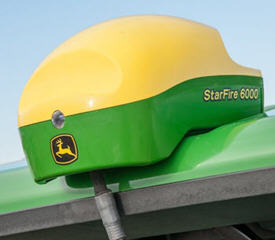 StarFire 6000 Receiver
StarFire 6000 Receiver
Selecting the right correction signal
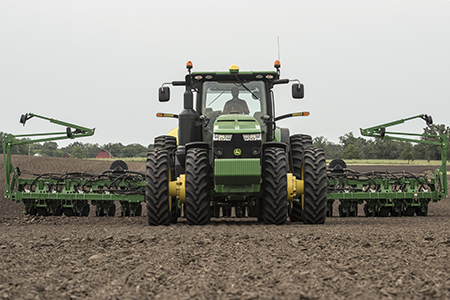 Achieve critical accuracy of in-field operations
Achieve critical accuracy of in-field operations
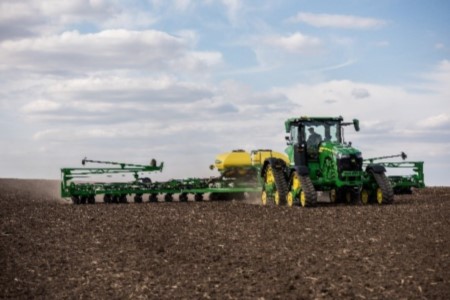 Achieve critical accuracy of in-field operations
Achieve critical accuracy of in-field operations
As equipment gets larger and margins tighter, accuracy of in-field operations and input placement is more critical than ever.
When making a pass in a field, traveling from one end of the field to another, the position accuracy of the return pass is critical. Pass-to-pass accuracy means the planter guess rows will be accurate and subsequent passes are less likely to result in crop damage.
Repeatability defines how accurately the receiver calculates its position over a relatively long time window.
Get started faster with improved pull-in performance
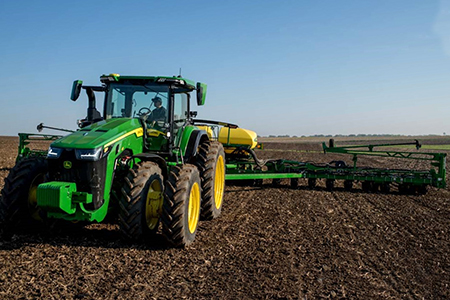 7290R Tractor pulling a 1795 Planter
7290R Tractor pulling a 1795 Planter
The StarFire™ 6000 Receiver offers 66 percent improved pull-in performance, SF2 versus SF3, compared to its predecessor. The StarFire 6000 Integrated Receiver offers an additional 33 percent improvement in SF3 pull-in compared to SF3 on the current StarFire 6000. This means the operator spends less time waiting for the receiver to achieve full accuracy and can start high-precision jobs like planting and nutrient application even faster. It also means less time waiting to reacquire full accuracy after an extended shading event, such as running next to trees while planting headlands.
StarFire 6000 and StarFire 6000 Integrated pull-in time:
- SF1: About 10 minutes
- SF3: Less than 30 minutes
- SF3: Less than 20 minutes with StarFire 6000 Integrated
- Radio RTK: Less than 1 minute
- Mobile RTK: Less than 1 minute
| Pull-in time | Pass-to-pass accuracy | |
| StarFire 6000 - SF1 About 10 minutes |
 |
 |
| StarFire 6000 - SF3 Less than 30 minutes |
 |
|
| StarFire 6000 Integrated - SF3 Less than 20 minutes |
 |
|
| StarFire 6000 - RTK Less than 1 minute |
 |
|
StarFire™ 6000 Receiver correction signal right choice tool
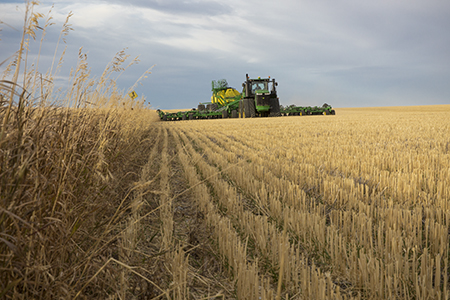
Utilize this tool to help select the right correction signal for the operation. Selecting the right signal ensures the level of accuracy can be achieved for desired in-field performance.
| SF1 | SF2* | SF3 | Radio RTK | Mobile RTK | |
| Pass-to-pass accuracy better than +/- 15 cm (5.9 in.) required? | No | Yes | Yes | Yes | Yes |
Horizontal pass-to-pass accuracy (15 minutes, 95 percent confidence) |
+/- 15 cm (5.9 in.) |
+/- 5 cm (2.0 in.) |
+/- 3 cm (1.2 in.) |
+/- 2.5 cm (1.0 in.) |
+/- 2.5 cm (1.0 in.) |
Possible wait time of up to 30 minutes after startup or extended periods of shading for full accuracy/ repeatability |
No |
--- |
Yes |
No |
No |
| Pull-in time | ~ 10 min | < 90 min | < 30 min | < 1 min | < 1 min |
| Long term (multiple season) repeatability required for guidance lines, coverage or boundaries? | No | No | No | Yes | Yes |
| Repeatability calculation | None | None | +/- 3 cm (1.2 in.) in-season |
+/- 2.5 cm (1.0 in.) long term | +/- 2.5 cm (1.0 in.) long term |
| Vertical accuracy important? | No | No | No | Yes | Yes |
| Delivery method | Satellite | Satellite | Satellite | Radio | Cellular |
| Operates in areas challenging for radio communication? | No | No | No | No | Yes |
| Activations required | None | SF2 ready | SF3 ready | SF3 ready and RTK ready |
SF3 ready and RTK ready |
| Subscription required | None | SF2 subscription | SF3 subscription | Dealer subscription or none (with own base station) | John Deere Mobile RTK subscription and JDLink™ subscription |
| Additional hardware required | None | None | None | RTK Radio | Modular Telematics Gateway (MTG) |
| Applications this differential correction is best suited for |
|
|
|
|
* NOTE: StarFire 3000 SF2 specs for comparison purposes only; not available with StarFire 6000.
Security PIN code
Protect investments with a security PIN code
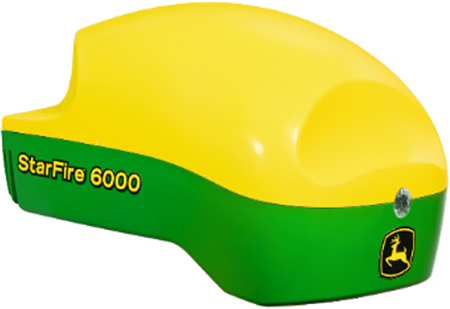 StarFire™ 6000 Receiver
StarFire™ 6000 Receiver
Producers have asked for a way to better secure their John Deere devices from improper use and thefts. With the 19-1 software update, John Deere added an enhancement to the user interface of the StarFire 6000 Receiver.
With this solution, producers have the choice to enable the security PIN code feature and set up a unique four-digit PIN code to enable and unlock their device, similar to a mobile device. Enabling this code will allow only users with the defined PIN code to access the device when it powers on.
This feature has two levels of access that can be defined. An administrator PIN code must be defined to enable the feature and should be used by the farm manager. A second optional operator PIN code can be defined for usage by operators of the machine.
Overview
| PIN code level | Functions | Main user |
| Administrator PIN code |
|
Farm manager |
| Operator PIN code |
|
Operator |
| Master unlock code |
|
Farm manager |
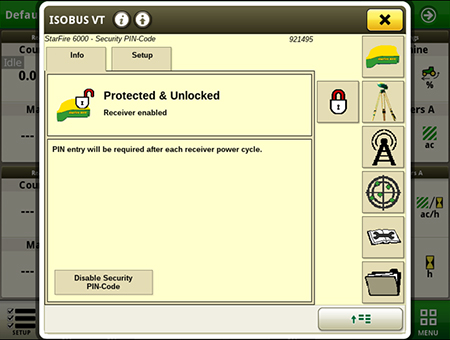 Enabling security PIN code feature
Enabling security PIN code feature
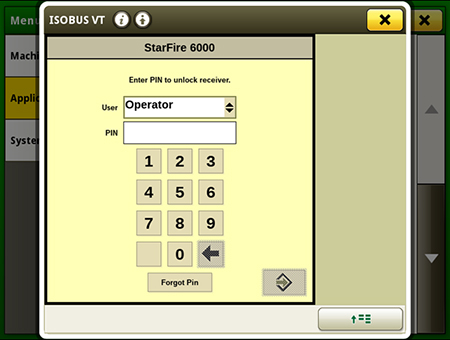 Entering the PIN to unlock the device
Entering the PIN to unlock the device
Features
Vertical forming chamber maintains uniform bale density
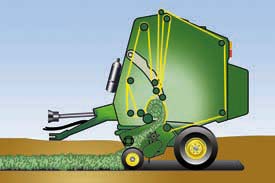 Bale-starting diagram
Bale-starting diagram
As the hay enters the forming chamber from the pickup, belts immediately turn the hay to form a tight, dense core.
Incoming hay then feeds between the bale and the lower gate roll. Hay is tightly compressed into smooth, dense layers as it enters the bale.
Chaffing is greatly reduced to prevent loss and retain hay quality in the bale.
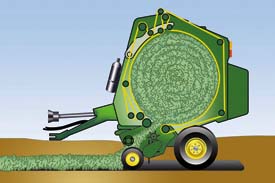 Full-sized bale in bale chamber
Full-sized bale in bale chamber
The idler arm rises with bale growth, forcing oil from the hydraulic cylinder through a pressure-relief valve to maintain uniform bale density throughout the bale-forming process.
MegaWide™ High Capacity and Cutting (HC2) feeding system
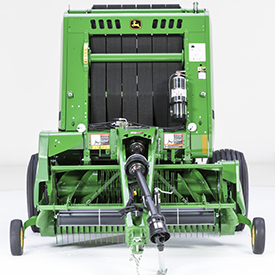
The 0 Series Round Baler family welcomes the first, John Deere, North-American built precutter. This feed system in front of these machines is the MegaWide HC2. The MegaWide Plus name is known as the industry-leading feed system since its introduction with the 7 Series Balers. John Deere continues that legacy with the 0 Series. Proven designs of the MegaWide were maintained and improvements were made to key components to gain significant capacity.
Features of the MegaWide HC2
The MegaWide™ HC2 will only be available in a precutter configuration (available on the 450M, 460M, 460R, 560M, and 560R models):
- 1.22-m (4-ft) wide machines will have 14 knives
- 1.52-m (5-ft) wide machines will have 20 knives
The MegaWide HC2 has the same 2.2-m (7.22-ft) MegaWide Plus pickup from the 9 Series. Dry hay and silage 0 Series configurations will also have the MegaWide Plus pickup.
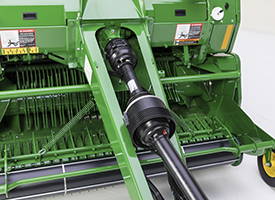
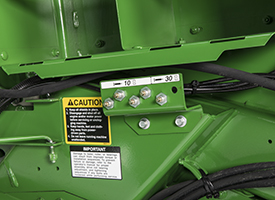
Before the introduction of the MegaWide HC2 , the cam-clutch protection for the driveline was only available on the 9 Series Premium Balers. It is in the base for the MegaWide HC2 precutter configurations. This driveline pushes the limitations of the baler and the MegaWide HC2 system by offering the best machine protection John Deere can provide.
Another feature brought over from the 9 Series Premium Balers and being offered on the 0 Series is the grease banks. All daily greasing can be done from the ground in one central location.
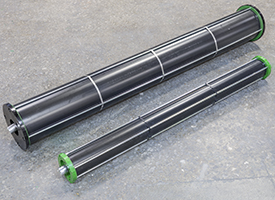 MegaWide HC2 roller baffle and MegaWide Plus roller baffles
MegaWide HC2 roller baffle and MegaWide Plus roller baffles
The roller baffle on the MegaWide HC2 doubled in size from the MegaWide Plus from 10.2-cm (4-in.) to 20.3-cm (8-in.) diameter to allow for increased speeds and performance in larger windrows.
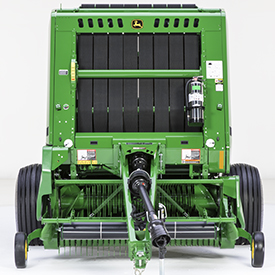
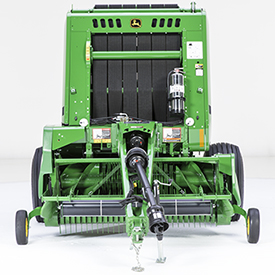
The 450M, 460M, 460R, 560M, and 560R Balers that can be configured with the MegaWide HC2 feed system will have the same flare-to-flare pickup width of 2.2 m (7.21 ft). This 2.2-m (7.21-ft), flare-to-flare, width on 1.22-m (4-ft) balers is only a feature of the MegaWide HC2 feed system.
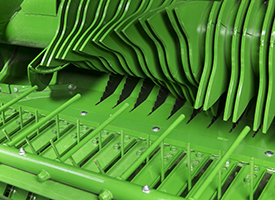 Primary rotor relationship to knives – front position
Primary rotor relationship to knives – front position
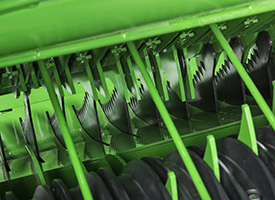 Primary rotor from bale chamber
Primary rotor from bale chamber
The primary rotor is only available on the MegaWide HC2 and is located directly behind the MegaWide pickups.
- This rotor grabs the crop and drags it over the knives to size the crop to a theoretical length size of 66 mm (2.5 in.)
- For the 1.22-m (4-ft) machines, there are 14 slots to receive the knives that are located on the floor of the feed system
- The 1.52-m (5-ft) machine has 20 knives and 20 slots
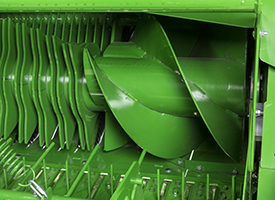 Fast-pitch augers on the primary rotor
Fast-pitch augers on the primary rotor
Industry-exclusive, fast-pitch augers have been placed on the primary rotor to move dry hay and silage past the transition points to avoid plugging.
 MegaWide HC2 secondary rotor from bale chamber
MegaWide HC2 secondary rotor from bale chamber
The secondary rotor is another component on the feed system that was re-designed from the MegaWide Plus feed system to handle the increased demands of the high-capacity system.
- The secondary rotor in the MegaWide HC2 is similar in location and design as the MegaWide Plus spiral rotor.
- The hex shaft on secondary rotor rotor on the MegaWide HC2 was increased from 3.2 cm (1.25 in.) from the MegaWide Plus to 3.8 cm (1.5 in.)
- The diameter of the tube was increased for additional strength and to prevent silage wrapping
- The number of tines was increased from two to three for additional capacity and flow of crop into the starter roll and chamber.
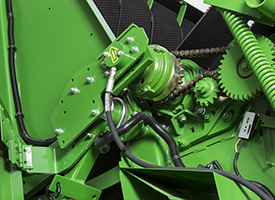
A third drive roll is another feature that will only be offered with the MegaWide HC2 feed system.
- Precutting crop releases additional moisture into the feed system of the baler so the MegaWide HC2 feed system added a third drive roll on the number 11 roller to ensure trouble-free bale formation even in the most difficult, high-moisture silage conditions.
- This feature is available only on the MegaWide HC2 feed system
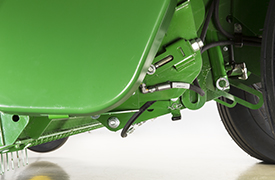
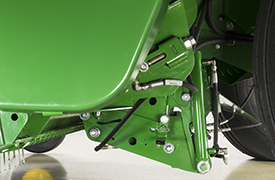
Drop floor – if the baler exceeds capacity and plugs, the MegaWide HC2 can lower the knife floor from the cab of the tractor to easily feed the plug into the chamber.
- Drop floor is an insurance policy to allow the operator to push the machine knowing that a plug can clear in 30 seconds, not 30 minutes.
- In factory-observed testing with the 2016 test fleet, 99 percent of the plugs were cleared from the cab.
- Floor is self-cleaning – when lowered to feed a plug, it allows chaff that has been built up around the knives to fall through into the windrow.
- This release of crop allows the feed system to stay cleaner
- Allows for easier engagement of the knives and servicing of the knives
- The floor is also responsible for engaging the knives
- Based on lack of success for re-engaging knives in competitive machines, John Deere made sure the MegaWide™ HC2 was built to meet the demands a Deere producer expects.
- Knife-engagement forces on the MegaWide™ HC2 are 10 times that of the New Holland™ Roll-Belt™ 460 CropCutter® Baler. It gives the producer the confidence that if the knives are engaged, they are all up and cutting.
- Once the knives are up, each knife has individual spring protection, limiting bent or broken knives.
- Hit a rock and the knife moves out of the way and automatically re-engages.
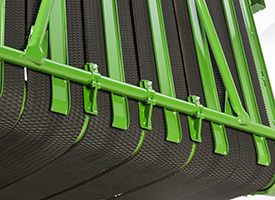
All MegaWide HC2 feed systems will have silage components to limit maintenance and prevent crop build up on belts.
- Driven auger
- Starter roll scraper knife
- Auxiliary take up roller
- For precutter machines only - external belt guides
- External belt guides were designed to dramatically reduce amount of chaff in the gate
- Available through parts – retrofittable through 7 Series balers
Descriptive model numbering system
All 0 Series Balers use alpha-numeric identifiers for the model names:
The MegaWide HC2 can be ordered on mid specification (M) and premium specification (R) balers.
R specification balers will have the premium pickup with improved internal components that are covered under the 2-year/12,000-bale premium warranty
M specification balers and pickups will not contain premium baler components – exception for this is the MegaWide HC2 feed system will have the premium cam clutch for the driveline and grease banks.
For more information about the model specifications, see the chart below:
| Baler option | Applicable models |
E = Economy
|
440E and 450E |
M = Standard
|
450M, 460M, 550M*, and 560M |
R = Premium
|
460R and 560R |
*NOTE: The 550M is only available in dry hay and silage configurations.
New Holland, Roll-Belt, and CropCutter are trademarks of CNH Global N.V. and its subsidiaries.
Increased torque – the MegaWide HC2 feed system required an additional drive configuration to power the primary rotor and to meet the capacity goals.
- The MegaWide HC2 feed system has a T gearbox where the MegaWide Plus has a 90 degree box.
- The MegaWide Plus system had a cut-out clutch that protected the spiral rotor and pickup.
- The MegaWide HC2 eliminated that clutch because the secondary rotor is more robust than the MegaWide Plus spiral rotor.
- This allowed the primary and secondary rotor to be driven directly from the driveline.
- Both components are still clutch protected from the main driveline cam clutch, but there is approximately 10 times more torque being put through the primary and secondary rotor than what is found on the MegaWide Plus spiral rotor.
- This exponential change in torque is the driving force of the capacity gains in the MegaWide HC2 feed system.
- MegaWide HC2 pickup is still clutched for extended pickup life. That clutch is now located on the left-hand side of the baler. MegaWide Plus pickup clutches are still located on the right-hand side of the baler.
MegaWide HC2 feed systems will not have the adjustable crank handle for the pickup.
- MegaWide Plus machines will continue to have this an option.
Exclusive DiamondTough™ belts with plate-type splices
 Staggered belts
Staggered belts
John Deere's 178-mm (7-in.) wide diamond-tread design ensures fast bale starts and grips the bale to prevent slippage and reduce chaffing. The treads are self-cleaning to reduce carryover. The belts are staggered to reduce the loss of fine material and are closely spaced to contain the hay for fast, easy starts.
The belts enclose 91 percent of the bale width to reduce loss of fine material and retain hay quality.
The staggered belt roll design enables any loose hay under or behind the belts to be returned to the pickup and into the baler. This design helps to prevent buildup at the front of the baler, which could cause hay loss and belt or splice damage.
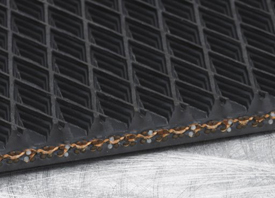 DiamondTough triple-weave belts
DiamondTough triple-weave belts

Every baler in the 0 Series Family uses DiamondTough belts. Belts are constructed using a patented triple-weave process of nylon and polyester materials.
They have the strength to handle heavy shock loads and help maintain consistent belt length.
The DiamondTough belts are more puncture and tear resistant than other belts on the market and provide improved belt life and reliability.
Plate-type fasteners
 Plate-type splices
Plate-type splices

All of the 0 Series Balers use the plate-type fasteners.
This closed-loop design uses a plate fastener with pre-assembled rivets that lock the fasteners into the belt, providing a powerful vice-type grip on the belt.
- The plates and rivets are manufactured from high-tensile stainless steel.
- Strong belt splices mean less maintenance and more productivity.
- The loop area is cold forged, making it extremely wear resistant in the coupling area, resulting in a very long cycle life.
- The spring steel pin is notched and locks into the splice connection without having to bend the pin or use external retainers.
0 Series Round Balers - Model specification levels
Round baler models
| Previous 9 Series models |
New 0 Series models |
|
| 449 | → | 440E |
| 459E | → | 450E |
| 459 | → | 450M |
| 459 Silage Special | ||
| 469 | → | 460M |
| 469 Silage Special | ||
| 469 Premium | → | 460R |
| 559 | → | 550M |
| 559 Silage Special | ||
| 569 | → | 560M |
| 569 Silage Special | ||
| 569 Premium | → | 560R |
Round baler model specification
| Baler option | Applicable models |
E = Economy
|
440E and 450E |
M = Standard
|
450M, 460M, 550M*, and 560M |
R = Premium
|
460R and 560R |
*NOTE: The 550M Round Baler will only be available in dry hay and silage configurations.
0 Series Balers have implemented specification levels for all models in the baler lineup similar to what was done when the 459E was introduced. Pickup options will remain the same for the new models equivalent specification. The precutter pickups will have the same MegaWide™ Plus pickups that will be offered in mid specification (M) or the premium specifications (R) balers.
Automatic electric-tie option using BaleTrak™ Pro monitor allows for more productivity
Audible alarm
 BaleTrak Pro monitor-controller
BaleTrak Pro monitor-controller
The BaleTrak Pro monitor-controller is included with the automatic electric tie option and the Edge-to-Edge option on the 450E Baler. The monitor sounds an alarm for near-full, full, and oversized bales.
- Monitor beeps once to notify the operator to even-up the bale prior to reaching the desired size.
- Monitor beeps twice when the bale reaches the desired size.
- If the operator continues to feed hay into the baler, the monitor will sound continuously to warn of an oversized bale.
- Bale shape bars are not available on the 440E or 450E Round Balers. The 440E and 450E Round Balers allow for adjustment of twine settings from the cab by using the BaleTrak Pro Monitor.
- The number of wraps on the Edge-to-Edge net wrap option on the 450E can be set with the BaleTrak Pro.
The audible level of the monitor can be adjusted.
Bale size adjustments can be made manually or automatically
 Manual bale size adjustment
Manual bale size adjustment
On the 440E Round Baler with hydraulic double-twine option, the near-full bale size warning can be adjusted by moving the nut (1) in the slot to match harvest requirements.
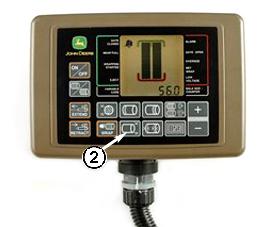 BaleTrak Pro bale size adjustment
BaleTrak Pro bale size adjustment
 MegaWide™ High Capacity and Cutting (HC2) system monitor
MegaWide™ High Capacity and Cutting (HC2) system monitor
The bale size on 450M, 450E with automatic electric tie, 550M, 460M, and 560M Round Balers can be adjusted from the operator's station with the BaleTrak™ Pro monitor-controller by pressing symbol 2, then pushing the +/- symbol.
Adjustable hitch to match wide array of tractor drawbar heights
 Side view of adjustable hitch
Side view of adjustable hitch
 Front view of adjustable hitch
Front view of adjustable hitch
The 9 Series Round Balers came standard with an adjustable hitch and this feature will continue to be in base with the 0 Series Round Balers. This feature allows the hitch height to be adjusted to optimize crop-feeding performance. Due to the wide array of tractor tire sizes and drawbar heights, hitch adjustment may be necessary to get the proper feed opening of the baler. The adjustable hitch eliminates the need for the 51-mm (2-in.) thick tractor drawbar kit (AE57344) because it has a wider opening.
Benefits of the adjustable hitch:
- Ability to match baler to numerous tire sizes
- Allows for drawbar height to fall within 330 mm to 559 mm (13 in. to 22 in.) from the top of the drawbar to the ground
- Eliminates narrow feed opening on the baler which can cause plugging
- Allows pickup head to follow terrain without missing crop
All eight bolts must be used when adjusting the hitch. There are four different positions as shown below:
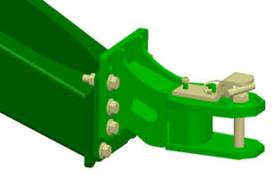 Position 1 (top) - regular and MegaTooth™ pickups
Position 1 (top) - regular and MegaTooth™ pickups
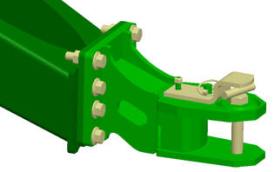 Position 2
Position 2
 Position 3 (factory setting) - MegaWide Plus and MegaWide HC2
Position 3 (factory setting) - MegaWide Plus and MegaWide HC2
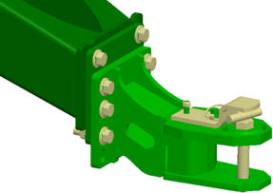 Position 4 (bottom)
Position 4 (bottom)
Also standard on all 0 Series Round Balers, except the 450E, is the drawbar flap. This helps to eliminate hay from getting caught on the hitch of the baler. The drawbar flap is designed to allow the operator to remove or attach the flap without having to unhook the baler from the tractor.
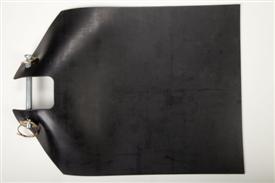 Drawbar flap
Drawbar flap
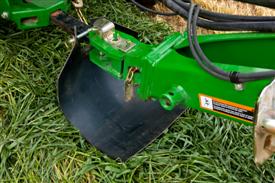 Drawbar flap installed on baler
Drawbar flap installed on baler
Additional features available on the 0 Series Premium Round Balers
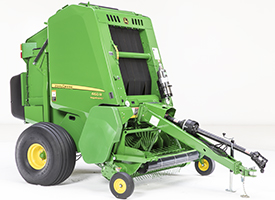
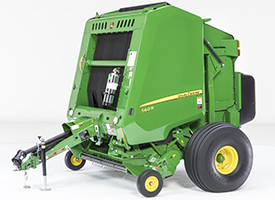
The gull wing doors from the 9 Series Premium Balers have been removed. All M- and R-specification 0 Series Balers will have the same stamped, steel door design.
Factory-installed grease bank
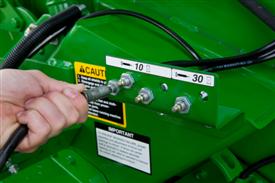 Grease bank
Grease bank

Standard on premium round balers is a factory-installed grease bank. This allows the operator to only have to grease eight zerks (four on each side of the baler) for grease zerks that were hard to reach on previous models. The operator will still have to grease the driveline and some other components on the baler.
NOTE: The grease bank will also be found on all 0 Series precutter configuration balers, M and R specification.
Third bale-shape sensor
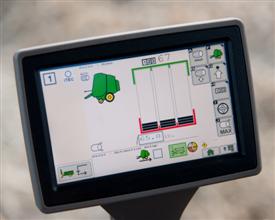 CommandCenter™ display with third bale shape sensor
CommandCenter™ display with third bale shape sensor

The 460R Premium and 560R Premium offer the producer a third bale-shape sensor that can be turned on or off. This will allow the operator to make consistent, square-shouldered bales since they can now see how the center of their bales are forming.
ISOBUS system
 Connection of ISO monitor wiring harness to the tractor
Connection of ISO monitor wiring harness to the tractor
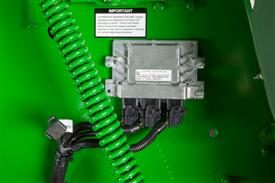 Controller on baler
Controller on baler
The ISOBUS system offered on the premium round balers allows the operator to use the latest technology when baling. They can utilize their GreenStar™ 2600, GreenStar 2630, GreenStar 1800, or certain R-Series CommandCenter displays as their baling monitor and can switch between tractors without having to take the display with them. All information for the baler is stored on the controller.
Warranty
A two-year or 12,000-bale warranty comes standard on 460R Premium and 560R Premium Round Balers only. Please see full product warranty for more details.
Silage configuration
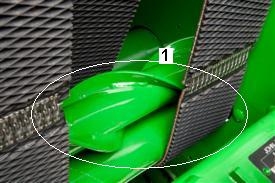 Staggered roller-auger kit
Staggered roller-auger kit

A silage-configuration baler allows the producer to put up silage hay. A silage configuration machine does not offer a precutter. There are three major components to a silage configuration baler: a staggered roller-auger kit (1), a starter roll-scraper knife, and a screen (2). The powered auger sits above the staggered roll on the baler to help keep wet hay from traveling up the belts and reduce buildup on the roll. The screen is bolted on the front of the baler as a safety feature. The knife/scraper is mounted in front of the starter roll to help prevent wrapping of wet crop on the starter roll.
The silage kit is offered as a bundle for field installation if the baler is not ordered as a silage-configuration machine from the factory. Attachment BE32442 is for 1.22-m (4-ft) wide machines and BE32443 is for1.52-m (5-ft) wide machines.
Also offered is a high-moisture kit. This kit does not include the same components that are on the silage-configuration balers. It offers the starter roll-scraper knife but does not include the staggered roll-auger kit. Attachment BE23828 is for 1.22-m (4-ft) machines and BE23829 is for 1.52-m (5-ft) machines.
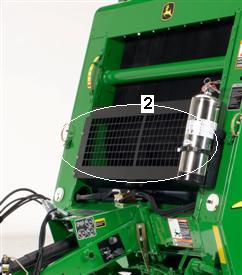 Starter roll knife and screen
Starter roll knife and screen

Base equipment on: 450M Silage, 550M Silage, 460M Silage, 560M Silage, 450M Precutter, 460M/R Precutter and 560M/R Precutter.
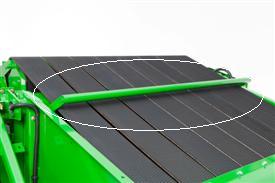 Auxiliary take-up rolls
Auxiliary take-up rolls

Auxiliary take-up rolls prevent belt crossover and flipping in wet conditions. This roll is base equipment on all silage and precutter configuration balers. It also comes with the bale ramp bundle on the 440E and 450E Balers.
Precutter configuration


The 0 Series Round Baler family welcomes the first, John Deere, North-American built precutter. This feed system in front of these machines is the MegaWide HC2. The MegaWide Plus name is known as the industry-leading feed system since its introduction with the 7 Series Balers. John Deere continues that legacy with the 0 Series. Proven designs of the MegaWide were maintained and improvements were made to key components to gain significant capacity.
The MegaWide™ HC2 will only be available in a precutter configuration (available on the 450M, 460M, 460R, 560M, and 560R models):
- 1.22-m (4-ft) wide machines will have 14 knives
- 1.52-m (5-ft) wide machines will have 20 knives
The MegaWide HC2 has the same 2.2-m (7.22-ft) MegaWide Plus pickup from the 9 Series. Dry hay and silage 0 Series configurations will also have the MegaWide Plus pickup.
MegaWide™ Plus pickup with MegaTough™ pickup teeth offers super capacity
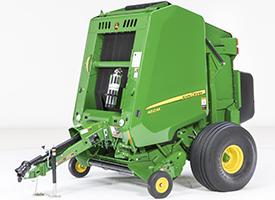 460M MegaWide Plus pickup
460M MegaWide Plus pickup
A MegaWide Plus pickup is available on 440E, 450M, 550M, and 560M Round Balers. It is base equipment on the 450M Silage, 550M Silage, 460M, 460M Silage, and 560M Silage Balers. The MegaWide Plus pickup is also incorporated into the new MegaWide High Capacity and Cutting (HC2) high-capacity precutter feed system.
0 Series Balers have implemented specification levels for all models in the baler lineup, similar to what was done when the 459E was introduced. Pickup options will remain the same for the new models equivalent specification. The precutter pickups will have the same MegaWide Plus pickups that will be offered in mid specification (M) or the premium specification (R) balers.
MegaWide Plus pickups make baling easier, especially in wide or windblown windrows, and increases productivity; more hay volume means more bales per hour.
- Flare-to-flare width of 1.8 m (5.9 ft) on balers with a 1.2 m (4-ft) wide bale chamber
- Flare-to-flare width of 2.2 m (7.2 ft) on balers with a 1.5-m (5-ft) wide bale chamber
- MegaWide Plus pickup makes it easier to produce better-shaped bales and improves crop pickup in wide, windblown, or scattered windrows
- Mega teeth, located at the ends of the pickup, pull crop around the flares when baling wide or windblown windrows
- MegaTough pickup teeth provide greater strength and durability
- Exclusive square design handles high-impact loads without yielding
- Sturdy toothbar design
- Self-adjusting roller baffle
- Spiral rotor-feed system improves feeding in all crop conditions
- Chain driven for positive feeding
- Cut-out clutch protected
- Semi-pneumatic gauge wheels
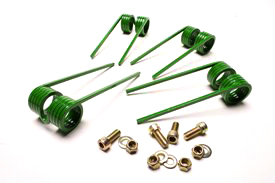 MegaTough pickup teeth
MegaTough pickup teeth
Mega and MegaTough pickup teeth are base equipment:
- Mega teeth, at the ends of the pickup, are heavy-duty for long life and improved crop retrieval
- MegaTough pickup teeth are designed to withstand the harshest baling conditions and provide long service life
 Toothbars on 1.5-m (5-ft) baler
Toothbars on 1.5-m (5-ft) baler
The 1.2-m (4-ft) balers use a full-length, reinforced toothbar design.
The 1.5-m (5-ft) balers use a heavy, C-channel construction. The pickup toothbars are divided into two half-sections that mount to a center spider for increased strength and even crop feeding.
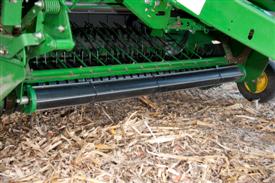 Roller baffle
Roller baffle
Available only on the MegaWide Plus pickup, the patented roller baffle is self-adjusting and produces smoother crop flow across the pickup. The roller also improves crop pickup in small windrows and prevents roll ahead of crop.
When combined with the MegaWide Plus pickup, this feeding system allows increased ground speed with less chance of plugging for increased productivity in all field conditions.
- Self-adjusting
- Smooths crop for even flow across pickup
- Allows for faster ground speed with less chance of plugging
- Increases operator productivity
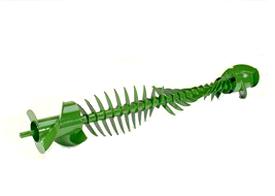 Spiral rotor
Spiral rotor
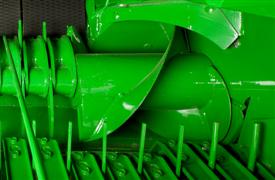 Auger and rotor feed system
Auger and rotor feed system
The MegaWide Plus pickup uses a rotor-feeding assembly, which mounts behind the pickup for smooth and even crop flow into the bale chamber.
- Augers and rotor teeth are driven on the same shaft, eliminating the need for additional drives.
- The rotor is fixed to the baler frame, allowing positive and even feeding into the bale chamber.
- Large-diameter converging augers have high crop-flow capacity, and auger scrolls help to force crop into the chamber.
- Spiral design enhances feeding in uneven windrows and reduces loading on the rotor.
 Rotor stripper
Rotor stripper
Rotor strippers allow crop to be lifted from the rotor teeth into the chamber without cutting or wrapping the crop.
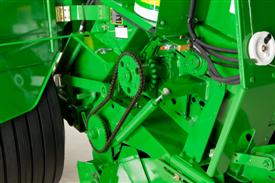 Cut-out clutch protection and feeder-drive chain
Cut-out clutch protection and feeder-drive chain
The MegaWide Plus pickups and spiral rotor are chain-driven for positive bale starts with cutout clutch protection. The pickup is being driven off the drive roll and bypasses the starter roll. This will allow for reduced wear and breakage of the starter roll chain.
 Semi-pneumatic gauge wheel
Semi-pneumatic gauge wheel
Semi-pneumatic gauge wheels provide smooth ground gauging over uneven terrain and protection to the pickup.
- Stiffer rubber sidewalls
- No air pressure to maintain, which mean no flat tires
- Adjustable to meet pickup tooth-to-stubble height requirements
The pickup float springs are positioned for excellent flotation.
- Adjustable to meet varying field conditions
- Float springs only support the pickup reel
- Rotor assembly is fixed to the baler frame, eliminating additional weight on the pickup system
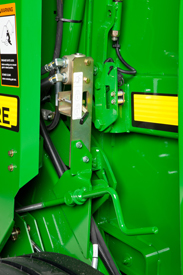 Adjustable crank handle
Adjustable crank handle
The adjusting crank positions the pickup to the desired operating height to match crop or field conditions.
An optional hydraulic pickup lift cylinder is available as an attachment.
- Makes raising for transport or clearing obstructions easy
- Crank handle serves as a down stop
- Adapts to regular, MegaTooth and MegaWide Plus pickups
- Hydraulic pickup lift comes standard on premium machines
Features
Vertical forming chamber maintains uniform bale density
 Bale-starting diagram
Bale-starting diagram
As the hay enters the forming chamber from the pickup, belts immediately turn the hay to form a tight, dense core.
Incoming hay then feeds between the bale and the lower gate roll. Hay is tightly compressed into smooth, dense layers as it enters the bale.
Chaffing is greatly reduced to prevent loss and retain hay quality in the bale.
 Full-sized bale in bale chamber
Full-sized bale in bale chamber
The idler arm rises with bale growth, forcing oil from the hydraulic cylinder through a pressure-relief valve to maintain uniform bale density throughout the bale-forming process.
MegaWide™ High Capacity and Cutting (HC2) feeding system

The 0 Series Round Baler family welcomes the first, John Deere, North-American built precutter. This feed system in front of these machines is the MegaWide HC2. The MegaWide Plus name is known as the industry-leading feed system since its introduction with the 7 Series Balers. John Deere continues that legacy with the 0 Series. Proven designs of the MegaWide were maintained and improvements were made to key components to gain significant capacity.
Features of the MegaWide HC2
The MegaWide™ HC2 will only be available in a precutter configuration (available on the 450M, 460M, 460R, 560M, and 560R models):
- 1.22-m (4-ft) wide machines will have 14 knives
- 1.52-m (5-ft) wide machines will have 20 knives
The MegaWide HC2 has the same 2.2-m (7.22-ft) MegaWide Plus pickup from the 9 Series. Dry hay and silage 0 Series configurations will also have the MegaWide Plus pickup.


Before the introduction of the MegaWide HC2 , the cam-clutch protection for the driveline was only available on the 9 Series Premium Balers. It is in the base for the MegaWide HC2 precutter configurations. This driveline pushes the limitations of the baler and the MegaWide HC2 system by offering the best machine protection John Deere can provide.
Another feature brought over from the 9 Series Premium Balers and being offered on the 0 Series is the grease banks. All daily greasing can be done from the ground in one central location.
 MegaWide HC2 roller baffle and MegaWide Plus roller baffles
MegaWide HC2 roller baffle and MegaWide Plus roller baffles
The roller baffle on the MegaWide HC2 doubled in size from the MegaWide Plus from 10.2-cm (4-in.) to 20.3-cm (8-in.) diameter to allow for increased speeds and performance in larger windrows.


The 450M, 460M, 460R, 560M, and 560R Balers that can be configured with the MegaWide HC2 feed system will have the same flare-to-flare pickup width of 2.2 m (7.21 ft). This 2.2-m (7.21-ft), flare-to-flare, width on 1.22-m (4-ft) balers is only a feature of the MegaWide HC2 feed system.
 Primary rotor relationship to knives – front position
Primary rotor relationship to knives – front position
 Primary rotor from bale chamber
Primary rotor from bale chamber
The primary rotor is only available on the MegaWide HC2 and is located directly behind the MegaWide pickups.
- This rotor grabs the crop and drags it over the knives to size the crop to a theoretical length size of 66 mm (2.5 in.)
- For the 1.22-m (4-ft) machines, there are 14 slots to receive the knives that are located on the floor of the feed system
- The 1.52-m (5-ft) machine has 20 knives and 20 slots
 Fast-pitch augers on the primary rotor
Fast-pitch augers on the primary rotor
Industry-exclusive, fast-pitch augers have been placed on the primary rotor to move dry hay and silage past the transition points to avoid plugging.
 MegaWide HC2 secondary rotor from bale chamber
MegaWide HC2 secondary rotor from bale chamber
The secondary rotor is another component on the feed system that was re-designed from the MegaWide Plus feed system to handle the increased demands of the high-capacity system.
- The secondary rotor in the MegaWide HC2 is similar in location and design as the MegaWide Plus spiral rotor.
- The hex shaft on secondary rotor rotor on the MegaWide HC2 was increased from 3.2 cm (1.25 in.) from the MegaWide Plus to 3.8 cm (1.5 in.)
- The diameter of the tube was increased for additional strength and to prevent silage wrapping
- The number of tines was increased from two to three for additional capacity and flow of crop into the starter roll and chamber.

A third drive roll is another feature that will only be offered with the MegaWide HC2 feed system.
- Precutting crop releases additional moisture into the feed system of the baler so the MegaWide HC2 feed system added a third drive roll on the number 11 roller to ensure trouble-free bale formation even in the most difficult, high-moisture silage conditions.
- This feature is available only on the MegaWide HC2 feed system


Drop floor – if the baler exceeds capacity and plugs, the MegaWide HC2 can lower the knife floor from the cab of the tractor to easily feed the plug into the chamber.
- Drop floor is an insurance policy to allow the operator to push the machine knowing that a plug can clear in 30 seconds, not 30 minutes.
- In factory-observed testing with the 2016 test fleet, 99 percent of the plugs were cleared from the cab.
- Floor is self-cleaning – when lowered to feed a plug, it allows chaff that has been built up around the knives to fall through into the windrow.
- This release of crop allows the feed system to stay cleaner
- Allows for easier engagement of the knives and servicing of the knives
- The floor is also responsible for engaging the knives
- Based on lack of success for re-engaging knives in competitive machines, John Deere made sure the MegaWide™ HC2 was built to meet the demands a Deere producer expects.
- Knife-engagement forces on the MegaWide™ HC2 are 10 times that of the New Holland™ Roll-Belt™ 460 CropCutter® Baler. It gives the producer the confidence that if the knives are engaged, they are all up and cutting.
- Once the knives are up, each knife has individual spring protection, limiting bent or broken knives.
- Hit a rock and the knife moves out of the way and automatically re-engages.

All MegaWide HC2 feed systems will have silage components to limit maintenance and prevent crop build up on belts.
- Driven auger
- Starter roll scraper knife
- Auxiliary take up roller
- For precutter machines only - external belt guides
- External belt guides were designed to dramatically reduce amount of chaff in the gate
- Available through parts – retrofittable through 7 Series balers
Descriptive model numbering system
All 0 Series Balers use alpha-numeric identifiers for the model names:
The MegaWide HC2 can be ordered on mid specification (M) and premium specification (R) balers.
R specification balers will have the premium pickup with improved internal components that are covered under the 2-year/12,000-bale premium warranty
M specification balers and pickups will not contain premium baler components – exception for this is the MegaWide HC2 feed system will have the premium cam clutch for the driveline and grease banks.
For more information about the model specifications, see the chart below:
| Baler option | Applicable models |
E = Economy
|
440E and 450E |
M = Standard
|
450M, 460M, 550M*, and 560M |
R = Premium
|
460R and 560R |
*NOTE: The 550M is only available in dry hay and silage configurations.
New Holland, Roll-Belt, and CropCutter are trademarks of CNH Global N.V. and its subsidiaries.
Increased torque – the MegaWide HC2 feed system required an additional drive configuration to power the primary rotor and to meet the capacity goals.
- The MegaWide HC2 feed system has a T gearbox where the MegaWide Plus has a 90 degree box.
- The MegaWide Plus system had a cut-out clutch that protected the spiral rotor and pickup.
- The MegaWide HC2 eliminated that clutch because the secondary rotor is more robust than the MegaWide Plus spiral rotor.
- This allowed the primary and secondary rotor to be driven directly from the driveline.
- Both components are still clutch protected from the main driveline cam clutch, but there is approximately 10 times more torque being put through the primary and secondary rotor than what is found on the MegaWide Plus spiral rotor.
- This exponential change in torque is the driving force of the capacity gains in the MegaWide HC2 feed system.
- MegaWide HC2 pickup is still clutched for extended pickup life. That clutch is now located on the left-hand side of the baler. MegaWide Plus pickup clutches are still located on the right-hand side of the baler.
MegaWide HC2 feed systems will not have the adjustable crank handle for the pickup.
- MegaWide Plus machines will continue to have this an option.
Exclusive DiamondTough™ belts with plate-type splices
 Staggered belts
Staggered belts
John Deere's 178-mm (7-in.) wide diamond-tread design ensures fast bale starts and grips the bale to prevent slippage and reduce chaffing. The treads are self-cleaning to reduce carryover. The belts are staggered to reduce the loss of fine material and are closely spaced to contain the hay for fast, easy starts.
The belts enclose 91 percent of the bale width to reduce loss of fine material and retain hay quality.
The staggered belt roll design enables any loose hay under or behind the belts to be returned to the pickup and into the baler. This design helps to prevent buildup at the front of the baler, which could cause hay loss and belt or splice damage.
 DiamondTough triple-weave belts
DiamondTough triple-weave belts

Every baler in the 0 Series Family uses DiamondTough belts. Belts are constructed using a patented triple-weave process of nylon and polyester materials.
They have the strength to handle heavy shock loads and help maintain consistent belt length.
The DiamondTough belts are more puncture and tear resistant than other belts on the market and provide improved belt life and reliability.
Plate-type fasteners
 Plate-type splices
Plate-type splices

All of the 0 Series Balers use the plate-type fasteners.
This closed-loop design uses a plate fastener with pre-assembled rivets that lock the fasteners into the belt, providing a powerful vice-type grip on the belt.
- The plates and rivets are manufactured from high-tensile stainless steel.
- Strong belt splices mean less maintenance and more productivity.
- The loop area is cold forged, making it extremely wear resistant in the coupling area, resulting in a very long cycle life.
- The spring steel pin is notched and locks into the splice connection without having to bend the pin or use external retainers.
0 Series Round Balers - Model specification levels
Round baler models
| Previous 9 Series models |
New 0 Series models |
|
| 449 | → | 440E |
| 459E | → | 450E |
| 459 | → | 450M |
| 459 Silage Special | ||
| 469 | → | 460M |
| 469 Silage Special | ||
| 469 Premium | → | 460R |
| 559 | → | 550M |
| 559 Silage Special | ||
| 569 | → | 560M |
| 569 Silage Special | ||
| 569 Premium | → | 560R |
Round baler model specification
| Baler option | Applicable models |
E = Economy
|
440E and 450E |
M = Standard
|
450M, 460M, 550M*, and 560M |
R = Premium
|
460R and 560R |
*NOTE: The 550M Round Baler will only be available in dry hay and silage configurations.
0 Series Balers have implemented specification levels for all models in the baler lineup similar to what was done when the 459E was introduced. Pickup options will remain the same for the new models equivalent specification. The precutter pickups will have the same MegaWide™ Plus pickups that will be offered in mid specification (M) or the premium specifications (R) balers.
Automatic electric-tie option using BaleTrak™ Pro monitor allows for more productivity
Audible alarm
 BaleTrak Pro monitor-controller
BaleTrak Pro monitor-controller
The BaleTrak Pro monitor-controller is included with the automatic electric tie option and the Edge-to-Edge option on the 450E Baler. The monitor sounds an alarm for near-full, full, and oversized bales.
- Monitor beeps once to notify the operator to even-up the bale prior to reaching the desired size.
- Monitor beeps twice when the bale reaches the desired size.
- If the operator continues to feed hay into the baler, the monitor will sound continuously to warn of an oversized bale.
- Bale shape bars are not available on the 440E or 450E Round Balers. The 440E and 450E Round Balers allow for adjustment of twine settings from the cab by using the BaleTrak Pro Monitor.
- The number of wraps on the Edge-to-Edge net wrap option on the 450E can be set with the BaleTrak Pro.
The audible level of the monitor can be adjusted.
Bale size adjustments can be made manually or automatically
 Manual bale size adjustment
Manual bale size adjustment
On the 440E Round Baler with hydraulic double-twine option, the near-full bale size warning can be adjusted by moving the nut (1) in the slot to match harvest requirements.
 BaleTrak Pro bale size adjustment
BaleTrak Pro bale size adjustment
 MegaWide™ High Capacity and Cutting (HC2) system monitor
MegaWide™ High Capacity and Cutting (HC2) system monitor
The bale size on 450M, 450E with automatic electric tie, 550M, 460M, and 560M Round Balers can be adjusted from the operator's station with the BaleTrak™ Pro monitor-controller by pressing symbol 2, then pushing the +/- symbol.
Adjustable hitch to match wide array of tractor drawbar heights
 Side view of adjustable hitch
Side view of adjustable hitch
 Front view of adjustable hitch
Front view of adjustable hitch
The 9 Series Round Balers came standard with an adjustable hitch and this feature will continue to be in base with the 0 Series Round Balers. This feature allows the hitch height to be adjusted to optimize crop-feeding performance. Due to the wide array of tractor tire sizes and drawbar heights, hitch adjustment may be necessary to get the proper feed opening of the baler. The adjustable hitch eliminates the need for the 51-mm (2-in.) thick tractor drawbar kit (AE57344) because it has a wider opening.
Benefits of the adjustable hitch:
- Ability to match baler to numerous tire sizes
- Allows for drawbar height to fall within 330 mm to 559 mm (13 in. to 22 in.) from the top of the drawbar to the ground
- Eliminates narrow feed opening on the baler which can cause plugging
- Allows pickup head to follow terrain without missing crop
All eight bolts must be used when adjusting the hitch. There are four different positions as shown below:
 Position 1 (top) - regular and MegaTooth™ pickups
Position 1 (top) - regular and MegaTooth™ pickups
 Position 2
Position 2
 Position 3 (factory setting) - MegaWide Plus and MegaWide HC2
Position 3 (factory setting) - MegaWide Plus and MegaWide HC2
 Position 4 (bottom)
Position 4 (bottom)
Also standard on all 0 Series Round Balers, except the 450E, is the drawbar flap. This helps to eliminate hay from getting caught on the hitch of the baler. The drawbar flap is designed to allow the operator to remove or attach the flap without having to unhook the baler from the tractor.
 Drawbar flap
Drawbar flap
 Drawbar flap installed on baler
Drawbar flap installed on baler
Additional features available on the 0 Series Premium Round Balers


The gull wing doors from the 9 Series Premium Balers have been removed. All M- and R-specification 0 Series Balers will have the same stamped, steel door design.
Factory-installed grease bank
 Grease bank
Grease bank

Standard on premium round balers is a factory-installed grease bank. This allows the operator to only have to grease eight zerks (four on each side of the baler) for grease zerks that were hard to reach on previous models. The operator will still have to grease the driveline and some other components on the baler.
NOTE: The grease bank will also be found on all 0 Series precutter configuration balers, M and R specification.
Third bale-shape sensor
 CommandCenter™ display with third bale shape sensor
CommandCenter™ display with third bale shape sensor

The 460R Premium and 560R Premium offer the producer a third bale-shape sensor that can be turned on or off. This will allow the operator to make consistent, square-shouldered bales since they can now see how the center of their bales are forming.
ISOBUS system
 Connection of ISO monitor wiring harness to the tractor
Connection of ISO monitor wiring harness to the tractor
 Controller on baler
Controller on baler
The ISOBUS system offered on the premium round balers allows the operator to use the latest technology when baling. They can utilize their GreenStar™ 2600, GreenStar 2630, GreenStar 1800, or certain R-Series CommandCenter displays as their baling monitor and can switch between tractors without having to take the display with them. All information for the baler is stored on the controller.
Warranty
A two-year or 12,000-bale warranty comes standard on 460R Premium and 560R Premium Round Balers only. Please see full product warranty for more details.
Silage configuration
 Staggered roller-auger kit
Staggered roller-auger kit

A silage-configuration baler allows the producer to put up silage hay. A silage configuration machine does not offer a precutter. There are three major components to a silage configuration baler: a staggered roller-auger kit (1), a starter roll-scraper knife, and a screen (2). The powered auger sits above the staggered roll on the baler to help keep wet hay from traveling up the belts and reduce buildup on the roll. The screen is bolted on the front of the baler as a safety feature. The knife/scraper is mounted in front of the starter roll to help prevent wrapping of wet crop on the starter roll.
The silage kit is offered as a bundle for field installation if the baler is not ordered as a silage-configuration machine from the factory. Attachment BE32442 is for 1.22-m (4-ft) wide machines and BE32443 is for1.52-m (5-ft) wide machines.
Also offered is a high-moisture kit. This kit does not include the same components that are on the silage-configuration balers. It offers the starter roll-scraper knife but does not include the staggered roll-auger kit. Attachment BE23828 is for 1.22-m (4-ft) machines and BE23829 is for 1.52-m (5-ft) machines.
 Starter roll knife and screen
Starter roll knife and screen

Base equipment on: 450M Silage, 550M Silage, 460M Silage, 560M Silage, 450M Precutter, 460M/R Precutter and 560M/R Precutter.
 Auxiliary take-up rolls
Auxiliary take-up rolls

Auxiliary take-up rolls prevent belt crossover and flipping in wet conditions. This roll is base equipment on all silage and precutter configuration balers. It also comes with the bale ramp bundle on the 440E and 450E Balers.
Precutter configuration


The 0 Series Round Baler family welcomes the first, John Deere, North-American built precutter. This feed system in front of these machines is the MegaWide HC2. The MegaWide Plus name is known as the industry-leading feed system since its introduction with the 7 Series Balers. John Deere continues that legacy with the 0 Series. Proven designs of the MegaWide were maintained and improvements were made to key components to gain significant capacity.
The MegaWide™ HC2 will only be available in a precutter configuration (available on the 450M, 460M, 460R, 560M, and 560R models):
- 1.22-m (4-ft) wide machines will have 14 knives
- 1.52-m (5-ft) wide machines will have 20 knives
The MegaWide HC2 has the same 2.2-m (7.22-ft) MegaWide Plus pickup from the 9 Series. Dry hay and silage 0 Series configurations will also have the MegaWide Plus pickup.
MegaWide™ Plus pickup with MegaTough™ pickup teeth offers super capacity
 460M MegaWide Plus pickup
460M MegaWide Plus pickup
A MegaWide Plus pickup is available on 440E, 450M, 550M, and 560M Round Balers. It is base equipment on the 450M Silage, 550M Silage, 460M, 460M Silage, and 560M Silage Balers. The MegaWide Plus pickup is also incorporated into the new MegaWide High Capacity and Cutting (HC2) high-capacity precutter feed system.
0 Series Balers have implemented specification levels for all models in the baler lineup, similar to what was done when the 459E was introduced. Pickup options will remain the same for the new models equivalent specification. The precutter pickups will have the same MegaWide Plus pickups that will be offered in mid specification (M) or the premium specification (R) balers.
MegaWide Plus pickups make baling easier, especially in wide or windblown windrows, and increases productivity; more hay volume means more bales per hour.
- Flare-to-flare width of 1.8 m (5.9 ft) on balers with a 1.2 m (4-ft) wide bale chamber
- Flare-to-flare width of 2.2 m (7.2 ft) on balers with a 1.5-m (5-ft) wide bale chamber
- MegaWide Plus pickup makes it easier to produce better-shaped bales and improves crop pickup in wide, windblown, or scattered windrows
- Mega teeth, located at the ends of the pickup, pull crop around the flares when baling wide or windblown windrows
- MegaTough pickup teeth provide greater strength and durability
- Exclusive square design handles high-impact loads without yielding
- Sturdy toothbar design
- Self-adjusting roller baffle
- Spiral rotor-feed system improves feeding in all crop conditions
- Chain driven for positive feeding
- Cut-out clutch protected
- Semi-pneumatic gauge wheels
 MegaTough pickup teeth
MegaTough pickup teeth
Mega and MegaTough pickup teeth are base equipment:
- Mega teeth, at the ends of the pickup, are heavy-duty for long life and improved crop retrieval
- MegaTough pickup teeth are designed to withstand the harshest baling conditions and provide long service life
 Toothbars on 1.5-m (5-ft) baler
Toothbars on 1.5-m (5-ft) baler
The 1.2-m (4-ft) balers use a full-length, reinforced toothbar design.
The 1.5-m (5-ft) balers use a heavy, C-channel construction. The pickup toothbars are divided into two half-sections that mount to a center spider for increased strength and even crop feeding.
 Roller baffle
Roller baffle
Available only on the MegaWide Plus pickup, the patented roller baffle is self-adjusting and produces smoother crop flow across the pickup. The roller also improves crop pickup in small windrows and prevents roll ahead of crop.
When combined with the MegaWide Plus pickup, this feeding system allows increased ground speed with less chance of plugging for increased productivity in all field conditions.
- Self-adjusting
- Smooths crop for even flow across pickup
- Allows for faster ground speed with less chance of plugging
- Increases operator productivity
 Spiral rotor
Spiral rotor
 Auger and rotor feed system
Auger and rotor feed system
The MegaWide Plus pickup uses a rotor-feeding assembly, which mounts behind the pickup for smooth and even crop flow into the bale chamber.
- Augers and rotor teeth are driven on the same shaft, eliminating the need for additional drives.
- The rotor is fixed to the baler frame, allowing positive and even feeding into the bale chamber.
- Large-diameter converging augers have high crop-flow capacity, and auger scrolls help to force crop into the chamber.
- Spiral design enhances feeding in uneven windrows and reduces loading on the rotor.
 Rotor stripper
Rotor stripper
Rotor strippers allow crop to be lifted from the rotor teeth into the chamber without cutting or wrapping the crop.
 Cut-out clutch protection and feeder-drive chain
Cut-out clutch protection and feeder-drive chain
The MegaWide Plus pickups and spiral rotor are chain-driven for positive bale starts with cutout clutch protection. The pickup is being driven off the drive roll and bypasses the starter roll. This will allow for reduced wear and breakage of the starter roll chain.
 Semi-pneumatic gauge wheel
Semi-pneumatic gauge wheel
Semi-pneumatic gauge wheels provide smooth ground gauging over uneven terrain and protection to the pickup.
- Stiffer rubber sidewalls
- No air pressure to maintain, which mean no flat tires
- Adjustable to meet pickup tooth-to-stubble height requirements
The pickup float springs are positioned for excellent flotation.
- Adjustable to meet varying field conditions
- Float springs only support the pickup reel
- Rotor assembly is fixed to the baler frame, eliminating additional weight on the pickup system
 Adjustable crank handle
Adjustable crank handle
The adjusting crank positions the pickup to the desired operating height to match crop or field conditions.
An optional hydraulic pickup lift cylinder is available as an attachment.
- Makes raising for transport or clearing obstructions easy
- Crank handle serves as a down stop
- Adapts to regular, MegaTooth and MegaWide Plus pickups
- Hydraulic pickup lift comes standard on premium machines
Features
Vertical forming chamber maintains uniform bale density
 Bale-starting diagram
Bale-starting diagram
As the hay enters the forming chamber from the pickup, belts immediately turn the hay to form a tight, dense core.
Incoming hay then feeds between the bale and the lower gate roll. Hay is tightly compressed into smooth, dense layers as it enters the bale.
Chaffing is greatly reduced to prevent loss and retain hay quality in the bale.
 Full-sized bale in bale chamber
Full-sized bale in bale chamber
The idler arm rises with bale growth, forcing oil from the hydraulic cylinder through a pressure-relief valve to maintain uniform bale density throughout the bale-forming process.
Exclusive DiamondTough™ belts with plate-type splices
 Staggered belts
Staggered belts
John Deere's 178-mm (7-in.) wide diamond-tread design ensures fast bale starts and grips the bale to prevent slippage and reduce chaffing. The treads are self-cleaning to reduce carryover. The belts are staggered to reduce the loss of fine material and are closely spaced to contain the hay for fast, easy starts.
The belts enclose 91 percent of the bale width to reduce loss of fine material and retain hay quality.
The staggered belt roll design enables any loose hay under or behind the belts to be returned to the pickup and into the baler. This design helps to prevent buildup at the front of the baler, which could cause hay loss and belt or splice damage.
 DiamondTough triple-weave belts
DiamondTough triple-weave belts

Every baler in the 0 Series Family uses DiamondTough belts. Belts are constructed using a patented triple-weave process of nylon and polyester materials.
They have the strength to handle heavy shock loads and help maintain consistent belt length.
The DiamondTough belts are more puncture and tear resistant than other belts on the market and provide improved belt life and reliability.
Plate-type fasteners
 Plate-type splices
Plate-type splices

All of the 0 Series Balers use the plate-type fasteners.
This closed-loop design uses a plate fastener with pre-assembled rivets that lock the fasteners into the belt, providing a powerful vice-type grip on the belt.
- The plates and rivets are manufactured from high-tensile stainless steel.
- Strong belt splices mean less maintenance and more productivity.
- The loop area is cold forged, making it extremely wear resistant in the coupling area, resulting in a very long cycle life.
- The spring steel pin is notched and locks into the splice connection without having to bend the pin or use external retainers.
0 Series Round Balers - Model specification levels
Round baler models
| Previous 9 Series models |
New 0 Series models |
|
| 449 | → | 440E |
| 459E | → | 450E |
| 459 | → | 450M |
| 459 Silage Special | ||
| 469 | → | 460M |
| 469 Silage Special | ||
| 469 Premium | → | 460R |
| 559 | → | 550M |
| 559 Silage Special | ||
| 569 | → | 560M |
| 569 Silage Special | ||
| 569 Premium | → | 560R |
Round baler model specification
| Baler option | Applicable models |
E = Economy
|
440E and 450E |
M = Standard
|
450M, 460M, 550M*, and 560M |
R = Premium
|
460R and 560R |
*NOTE: The 550M Round Baler will only be available in dry hay and silage configurations.
0 Series Balers have implemented specification levels for all models in the baler lineup similar to what was done when the 459E was introduced. Pickup options will remain the same for the new models equivalent specification. The precutter pickups will have the same MegaWide™ Plus pickups that will be offered in mid specification (M) or the premium specifications (R) balers.
Automatic electric-tie option using BaleTrak™ Pro monitor allows for more productivity
Audible alarm
 BaleTrak Pro monitor-controller
BaleTrak Pro monitor-controller
The BaleTrak Pro monitor-controller is included with the automatic electric tie option and the Edge-to-Edge option on the 450E Baler. The monitor sounds an alarm for near-full, full, and oversized bales.
- Monitor beeps once to notify the operator to even-up the bale prior to reaching the desired size.
- Monitor beeps twice when the bale reaches the desired size.
- If the operator continues to feed hay into the baler, the monitor will sound continuously to warn of an oversized bale.
- Bale shape bars are not available on the 440E or 450E Round Balers. The 440E and 450E Round Balers allow for adjustment of twine settings from the cab by using the BaleTrak Pro Monitor.
- The number of wraps on the Edge-to-Edge net wrap option on the 450E can be set with the BaleTrak Pro.
The audible level of the monitor can be adjusted.
Regular pickup offers large feed opening and low-profile, mid-mounted pickup
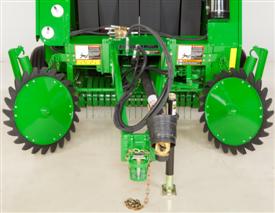 Regular pickup on 450E Baler with converging wheels
Regular pickup on 450E Baler with converging wheels
Mounted in front of the baler wheels and directly below the bale chamber, the pickup hugs the ground for clean crop retrieval. Hay movement is minimized.
- V-belt driven
- 440E, 450E, and 450M Baler pickups are 116.6 cm (45.9 in.) wide
- 550M and 560M Baler pickups are 156 cm (61.4 in.) wide
- Large reel shaft and reel bearing
The small-diameter, low-profile pickup allows for good ground gauging and clean crop retrieval.
- Handles large, heavy windrows of hay and high-moisture crops
- Feeds hay directly to the forming chamber to reduce crop loss
- Low-profile pickup minimizes hay lift to reduce chaffing and retain hay quality
Side flares prevent hay from blowing off of the pickup ends, which reduces hay loss.
The closely-spaced pickup teeth extend to the baler side sheets to help build straight-edged bales.
Standard on regular pickups, compressor rods are contoured to control hay over the pickup radius for positive feeding. The compressor rack can be adjusted upward or downward to match the volume of material in the windrow and can be easily removed to match crop conditions.
 Adjustable crank handle
Adjustable crank handle
The adjusting crank positions the pickup to the desired operating height to match crop or field conditions.
An optional hydraulic pickup lift cylinder is available as an attachment.
- Makes raising for transport or clearing obstructions easy
- Crank handle serves as a down stop
- Adapts to regular and MegaWide™ Plus pickups
- Hydraulic pickup lift comes standard on premium machines
NOTE: Crank is not an option for the MegaWide High Capacity and Cutting (HC2) feed system.
Bale size adjustments can be made manually or automatically
 Manual bale size adjustment
Manual bale size adjustment
On the 440E Round Baler with hydraulic double-twine option, the near-full bale size warning can be adjusted by moving the nut (1) in the slot to match harvest requirements.
 BaleTrak Pro bale size adjustment
BaleTrak Pro bale size adjustment
 MegaWide™ High Capacity and Cutting (HC2) system monitor
MegaWide™ High Capacity and Cutting (HC2) system monitor
The bale size on 450M, 450E with automatic electric tie, 550M, 460M, and 560M Round Balers can be adjusted from the operator's station with the BaleTrak™ Pro monitor-controller by pressing symbol 2, then pushing the +/- symbol.
Adjustable hitch to match wide array of tractor drawbar heights
 Side view of adjustable hitch
Side view of adjustable hitch
 Front view of adjustable hitch
Front view of adjustable hitch
The 9 Series Round Balers came standard with an adjustable hitch and this feature will continue to be in base with the 0 Series Round Balers. This feature allows the hitch height to be adjusted to optimize crop-feeding performance. Due to the wide array of tractor tire sizes and drawbar heights, hitch adjustment may be necessary to get the proper feed opening of the baler. The adjustable hitch eliminates the need for the 51-mm (2-in.) thick tractor drawbar kit (AE57344) because it has a wider opening.
Benefits of the adjustable hitch:
- Ability to match baler to numerous tire sizes
- Allows for drawbar height to fall within 330 mm to 559 mm (13 in. to 22 in.) from the top of the drawbar to the ground
- Eliminates narrow feed opening on the baler which can cause plugging
- Allows pickup head to follow terrain without missing crop
All eight bolts must be used when adjusting the hitch. There are four different positions as shown below:
 Position 1 (top) - regular and MegaTooth™ pickups
Position 1 (top) - regular and MegaTooth™ pickups
 Position 2
Position 2
 Position 3 (factory setting) - MegaWide Plus and MegaWide HC2
Position 3 (factory setting) - MegaWide Plus and MegaWide HC2
 Position 4 (bottom)
Position 4 (bottom)
Also standard on all 0 Series Round Balers, except the 450E, is the drawbar flap. This helps to eliminate hay from getting caught on the hitch of the baler. The drawbar flap is designed to allow the operator to remove or attach the flap without having to unhook the baler from the tractor.
 Drawbar flap
Drawbar flap
 Drawbar flap installed on baler
Drawbar flap installed on baler
Silage configuration
 Staggered roller-auger kit
Staggered roller-auger kit

A silage-configuration baler allows the producer to put up silage hay. A silage configuration machine does not offer a precutter. There are three major components to a silage configuration baler: a staggered roller-auger kit (1), a starter roll-scraper knife, and a screen (2). The powered auger sits above the staggered roll on the baler to help keep wet hay from traveling up the belts and reduce buildup on the roll. The screen is bolted on the front of the baler as a safety feature. The knife/scraper is mounted in front of the starter roll to help prevent wrapping of wet crop on the starter roll.
The silage kit is offered as a bundle for field installation if the baler is not ordered as a silage-configuration machine from the factory. Attachment BE32442 is for 1.22-m (4-ft) wide machines and BE32443 is for1.52-m (5-ft) wide machines.
Also offered is a high-moisture kit. This kit does not include the same components that are on the silage-configuration balers. It offers the starter roll-scraper knife but does not include the staggered roll-auger kit. Attachment BE23828 is for 1.22-m (4-ft) machines and BE23829 is for 1.52-m (5-ft) machines.
 Starter roll knife and screen
Starter roll knife and screen

Base equipment on: 450M Silage, 550M Silage, 460M Silage, 560M Silage, 450M Precutter, 460M/R Precutter and 560M/R Precutter.
 Auxiliary take-up rolls
Auxiliary take-up rolls

Auxiliary take-up rolls prevent belt crossover and flipping in wet conditions. This roll is base equipment on all silage and precutter configuration balers. It also comes with the bale ramp bundle on the 440E and 450E Balers.
Precutter configuration


The 0 Series Round Baler family welcomes the first, John Deere, North-American built precutter. This feed system in front of these machines is the MegaWide HC2. The MegaWide Plus name is known as the industry-leading feed system since its introduction with the 7 Series Balers. John Deere continues that legacy with the 0 Series. Proven designs of the MegaWide were maintained and improvements were made to key components to gain significant capacity.
The MegaWide™ HC2 will only be available in a precutter configuration (available on the 450M, 460M, 460R, 560M, and 560R models):
- 1.22-m (4-ft) wide machines will have 14 knives
- 1.52-m (5-ft) wide machines will have 20 knives
The MegaWide HC2 has the same 2.2-m (7.22-ft) MegaWide Plus pickup from the 9 Series. Dry hay and silage 0 Series configurations will also have the MegaWide Plus pickup.
MegaWide™ Plus pickup with MegaTough™ pickup teeth offers super capacity
 460M MegaWide Plus pickup
460M MegaWide Plus pickup
A MegaWide Plus pickup is available on 440E, 450M, 550M, and 560M Round Balers. It is base equipment on the 450M Silage, 550M Silage, 460M, 460M Silage, and 560M Silage Balers. The MegaWide Plus pickup is also incorporated into the new MegaWide High Capacity and Cutting (HC2) high-capacity precutter feed system.
0 Series Balers have implemented specification levels for all models in the baler lineup, similar to what was done when the 459E was introduced. Pickup options will remain the same for the new models equivalent specification. The precutter pickups will have the same MegaWide Plus pickups that will be offered in mid specification (M) or the premium specification (R) balers.
MegaWide Plus pickups make baling easier, especially in wide or windblown windrows, and increases productivity; more hay volume means more bales per hour.
- Flare-to-flare width of 1.8 m (5.9 ft) on balers with a 1.2 m (4-ft) wide bale chamber
- Flare-to-flare width of 2.2 m (7.2 ft) on balers with a 1.5-m (5-ft) wide bale chamber
- MegaWide Plus pickup makes it easier to produce better-shaped bales and improves crop pickup in wide, windblown, or scattered windrows
- Mega teeth, located at the ends of the pickup, pull crop around the flares when baling wide or windblown windrows
- MegaTough pickup teeth provide greater strength and durability
- Exclusive square design handles high-impact loads without yielding
- Sturdy toothbar design
- Self-adjusting roller baffle
- Spiral rotor-feed system improves feeding in all crop conditions
- Chain driven for positive feeding
- Cut-out clutch protected
- Semi-pneumatic gauge wheels
 MegaTough pickup teeth
MegaTough pickup teeth
Mega and MegaTough pickup teeth are base equipment:
- Mega teeth, at the ends of the pickup, are heavy-duty for long life and improved crop retrieval
- MegaTough pickup teeth are designed to withstand the harshest baling conditions and provide long service life
 Toothbars on 1.5-m (5-ft) baler
Toothbars on 1.5-m (5-ft) baler
The 1.2-m (4-ft) balers use a full-length, reinforced toothbar design.
The 1.5-m (5-ft) balers use a heavy, C-channel construction. The pickup toothbars are divided into two half-sections that mount to a center spider for increased strength and even crop feeding.
 Roller baffle
Roller baffle
Available only on the MegaWide Plus pickup, the patented roller baffle is self-adjusting and produces smoother crop flow across the pickup. The roller also improves crop pickup in small windrows and prevents roll ahead of crop.
When combined with the MegaWide Plus pickup, this feeding system allows increased ground speed with less chance of plugging for increased productivity in all field conditions.
- Self-adjusting
- Smooths crop for even flow across pickup
- Allows for faster ground speed with less chance of plugging
- Increases operator productivity
 Spiral rotor
Spiral rotor
 Auger and rotor feed system
Auger and rotor feed system
The MegaWide Plus pickup uses a rotor-feeding assembly, which mounts behind the pickup for smooth and even crop flow into the bale chamber.
- Augers and rotor teeth are driven on the same shaft, eliminating the need for additional drives.
- The rotor is fixed to the baler frame, allowing positive and even feeding into the bale chamber.
- Large-diameter converging augers have high crop-flow capacity, and auger scrolls help to force crop into the chamber.
- Spiral design enhances feeding in uneven windrows and reduces loading on the rotor.
 Rotor stripper
Rotor stripper
Rotor strippers allow crop to be lifted from the rotor teeth into the chamber without cutting or wrapping the crop.
 Cut-out clutch protection and feeder-drive chain
Cut-out clutch protection and feeder-drive chain
The MegaWide Plus pickups and spiral rotor are chain-driven for positive bale starts with cutout clutch protection. The pickup is being driven off the drive roll and bypasses the starter roll. This will allow for reduced wear and breakage of the starter roll chain.
 Semi-pneumatic gauge wheel
Semi-pneumatic gauge wheel
Semi-pneumatic gauge wheels provide smooth ground gauging over uneven terrain and protection to the pickup.
- Stiffer rubber sidewalls
- No air pressure to maintain, which mean no flat tires
- Adjustable to meet pickup tooth-to-stubble height requirements
The pickup float springs are positioned for excellent flotation.
- Adjustable to meet varying field conditions
- Float springs only support the pickup reel
- Rotor assembly is fixed to the baler frame, eliminating additional weight on the pickup system
 Adjustable crank handle
Adjustable crank handle
The adjusting crank positions the pickup to the desired operating height to match crop or field conditions.
An optional hydraulic pickup lift cylinder is available as an attachment.
- Makes raising for transport or clearing obstructions easy
- Crank handle serves as a down stop
- Adapts to regular, MegaTooth and MegaWide Plus pickups
- Hydraulic pickup lift comes standard on premium machines
Features
0 Series Round Balers - Model specification levels
Round baler models
| Previous 9 Series models |
New 0 Series models |
|
| 449 | → | 440E |
| 459E | → | 450E |
| 459 | → | 450M |
| 459 Silage Special | ||
| 469 | → | 460M |
| 469 Silage Special | ||
| 469 Premium | → | 460R |
| 559 | → | 550M |
| 559 Silage Special | ||
| 569 | → | 560M |
| 569 Silage Special | ||
| 569 Premium | → | 560R |
Round baler model specification
| Baler option | Applicable models |
E = Economy
|
440E and 450E |
M = Standard
|
450M, 460M, 550M*, and 560M |
R = Premium
|
460R and 560R |
*NOTE: The 550M Round Baler will only be available in dry hay and silage configurations.
0 Series Balers have implemented specification levels for all models in the baler lineup similar to what was done when the 459E was introduced. Pickup options will remain the same for the new models equivalent specification. The precutter pickups will have the same MegaWide™ Plus pickups that will be offered in mid specification (M) or the premium specifications (R) balers.
Automatic electric-tie option using BaleTrak™ Pro monitor allows for more productivity
Audible alarm
 BaleTrak Pro monitor-controller
BaleTrak Pro monitor-controller
The BaleTrak Pro monitor-controller is included with the automatic electric tie option and the Edge-to-Edge option on the 450E Baler. The monitor sounds an alarm for near-full, full, and oversized bales.
- Monitor beeps once to notify the operator to even-up the bale prior to reaching the desired size.
- Monitor beeps twice when the bale reaches the desired size.
- If the operator continues to feed hay into the baler, the monitor will sound continuously to warn of an oversized bale.
- Bale shape bars are not available on the 440E or 450E Round Balers. The 440E and 450E Round Balers allow for adjustment of twine settings from the cab by using the BaleTrak Pro Monitor.
- The number of wraps on the Edge-to-Edge net wrap option on the 450E can be set with the BaleTrak Pro.
The audible level of the monitor can be adjusted.
Adjustable hitch to match wide array of tractor drawbar heights
 Side view of adjustable hitch
Side view of adjustable hitch
 Front view of adjustable hitch
Front view of adjustable hitch
The 9 Series Round Balers came standard with an adjustable hitch and this feature will continue to be in base with the 0 Series Round Balers. This feature allows the hitch height to be adjusted to optimize crop-feeding performance. Due to the wide array of tractor tire sizes and drawbar heights, hitch adjustment may be necessary to get the proper feed opening of the baler. The adjustable hitch eliminates the need for the 51-mm (2-in.) thick tractor drawbar kit (AE57344) because it has a wider opening.
Benefits of the adjustable hitch:
- Ability to match baler to numerous tire sizes
- Allows for drawbar height to fall within 330 mm to 559 mm (13 in. to 22 in.) from the top of the drawbar to the ground
- Eliminates narrow feed opening on the baler which can cause plugging
- Allows pickup head to follow terrain without missing crop
All eight bolts must be used when adjusting the hitch. There are four different positions as shown below:
 Position 1 (top) - regular and MegaTooth™ pickups
Position 1 (top) - regular and MegaTooth™ pickups
 Position 2
Position 2
 Position 3 (factory setting) - MegaWide Plus and MegaWide HC2
Position 3 (factory setting) - MegaWide Plus and MegaWide HC2
 Position 4 (bottom)
Position 4 (bottom)
Also standard on all 0 Series Round Balers, except the 450E, is the drawbar flap. This helps to eliminate hay from getting caught on the hitch of the baler. The drawbar flap is designed to allow the operator to remove or attach the flap without having to unhook the baler from the tractor.
 Drawbar flap
Drawbar flap
 Drawbar flap installed on baler
Drawbar flap installed on baler
Regular pickup offers large feed opening and low-profile, mid-mounted pickup
 Regular pickup on 450E Baler with converging wheels
Regular pickup on 450E Baler with converging wheels
Mounted in front of the baler wheels and directly below the bale chamber, the pickup hugs the ground for clean crop retrieval. Hay movement is minimized.
- V-belt driven
- 440E, 450E, and 450M Baler pickups are 116.6 cm (45.9 in.) wide
- 550M and 560M Baler pickups are 156 cm (61.4 in.) wide
- Large reel shaft and reel bearing
The small-diameter, low-profile pickup allows for good ground gauging and clean crop retrieval.
- Handles large, heavy windrows of hay and high-moisture crops
- Feeds hay directly to the forming chamber to reduce crop loss
- Low-profile pickup minimizes hay lift to reduce chaffing and retain hay quality
Side flares prevent hay from blowing off of the pickup ends, which reduces hay loss.
The closely-spaced pickup teeth extend to the baler side sheets to help build straight-edged bales.
Standard on regular pickups, compressor rods are contoured to control hay over the pickup radius for positive feeding. The compressor rack can be adjusted upward or downward to match the volume of material in the windrow and can be easily removed to match crop conditions.
 Adjustable crank handle
Adjustable crank handle
The adjusting crank positions the pickup to the desired operating height to match crop or field conditions.
An optional hydraulic pickup lift cylinder is available as an attachment.
- Makes raising for transport or clearing obstructions easy
- Crank handle serves as a down stop
- Adapts to regular and MegaWide™ Plus pickups
- Hydraulic pickup lift comes standard on premium machines
NOTE: Crank is not an option for the MegaWide High Capacity and Cutting (HC2) feed system.
MegaWide™ Plus pickup with MegaTough™ pickup teeth offers super capacity
 460M MegaWide Plus pickup
460M MegaWide Plus pickup
A MegaWide Plus pickup is available on 440E, 450M, 550M, and 560M Round Balers. It is base equipment on the 450M Silage, 550M Silage, 460M, 460M Silage, and 560M Silage Balers. The MegaWide Plus pickup is also incorporated into the new MegaWide High Capacity and Cutting (HC2) high-capacity precutter feed system.
0 Series Balers have implemented specification levels for all models in the baler lineup, similar to what was done when the 459E was introduced. Pickup options will remain the same for the new models equivalent specification. The precutter pickups will have the same MegaWide Plus pickups that will be offered in mid specification (M) or the premium specification (R) balers.
MegaWide Plus pickups make baling easier, especially in wide or windblown windrows, and increases productivity; more hay volume means more bales per hour.
- Flare-to-flare width of 1.8 m (5.9 ft) on balers with a 1.2 m (4-ft) wide bale chamber
- Flare-to-flare width of 2.2 m (7.2 ft) on balers with a 1.5-m (5-ft) wide bale chamber
- MegaWide Plus pickup makes it easier to produce better-shaped bales and improves crop pickup in wide, windblown, or scattered windrows
- Mega teeth, located at the ends of the pickup, pull crop around the flares when baling wide or windblown windrows
- MegaTough pickup teeth provide greater strength and durability
- Exclusive square design handles high-impact loads without yielding
- Sturdy toothbar design
- Self-adjusting roller baffle
- Spiral rotor-feed system improves feeding in all crop conditions
- Chain driven for positive feeding
- Cut-out clutch protected
- Semi-pneumatic gauge wheels
 MegaTough pickup teeth
MegaTough pickup teeth
Mega and MegaTough pickup teeth are base equipment:
- Mega teeth, at the ends of the pickup, are heavy-duty for long life and improved crop retrieval
- MegaTough pickup teeth are designed to withstand the harshest baling conditions and provide long service life
 Toothbars on 1.5-m (5-ft) baler
Toothbars on 1.5-m (5-ft) baler
The 1.2-m (4-ft) balers use a full-length, reinforced toothbar design.
The 1.5-m (5-ft) balers use a heavy, C-channel construction. The pickup toothbars are divided into two half-sections that mount to a center spider for increased strength and even crop feeding.
 Roller baffle
Roller baffle
Available only on the MegaWide Plus pickup, the patented roller baffle is self-adjusting and produces smoother crop flow across the pickup. The roller also improves crop pickup in small windrows and prevents roll ahead of crop.
When combined with the MegaWide Plus pickup, this feeding system allows increased ground speed with less chance of plugging for increased productivity in all field conditions.
- Self-adjusting
- Smooths crop for even flow across pickup
- Allows for faster ground speed with less chance of plugging
- Increases operator productivity
 Spiral rotor
Spiral rotor
 Auger and rotor feed system
Auger and rotor feed system
The MegaWide Plus pickup uses a rotor-feeding assembly, which mounts behind the pickup for smooth and even crop flow into the bale chamber.
- Augers and rotor teeth are driven on the same shaft, eliminating the need for additional drives.
- The rotor is fixed to the baler frame, allowing positive and even feeding into the bale chamber.
- Large-diameter converging augers have high crop-flow capacity, and auger scrolls help to force crop into the chamber.
- Spiral design enhances feeding in uneven windrows and reduces loading on the rotor.
 Rotor stripper
Rotor stripper
Rotor strippers allow crop to be lifted from the rotor teeth into the chamber without cutting or wrapping the crop.
 Cut-out clutch protection and feeder-drive chain
Cut-out clutch protection and feeder-drive chain
The MegaWide Plus pickups and spiral rotor are chain-driven for positive bale starts with cutout clutch protection. The pickup is being driven off the drive roll and bypasses the starter roll. This will allow for reduced wear and breakage of the starter roll chain.
 Semi-pneumatic gauge wheel
Semi-pneumatic gauge wheel
Semi-pneumatic gauge wheels provide smooth ground gauging over uneven terrain and protection to the pickup.
- Stiffer rubber sidewalls
- No air pressure to maintain, which mean no flat tires
- Adjustable to meet pickup tooth-to-stubble height requirements
The pickup float springs are positioned for excellent flotation.
- Adjustable to meet varying field conditions
- Float springs only support the pickup reel
- Rotor assembly is fixed to the baler frame, eliminating additional weight on the pickup system
 Adjustable crank handle
Adjustable crank handle
The adjusting crank positions the pickup to the desired operating height to match crop or field conditions.
An optional hydraulic pickup lift cylinder is available as an attachment.
- Makes raising for transport or clearing obstructions easy
- Crank handle serves as a down stop
- Adapts to regular, MegaTooth and MegaWide Plus pickups
- Hydraulic pickup lift comes standard on premium machines
Vertical forming chamber maintains uniform bale density
 Bale-starting diagram
Bale-starting diagram
As the hay enters the forming chamber from the pickup, belts immediately turn the hay to form a tight, dense core.
Incoming hay then feeds between the bale and the lower gate roll. Hay is tightly compressed into smooth, dense layers as it enters the bale.
Chaffing is greatly reduced to prevent loss and retain hay quality in the bale.
 Full-sized bale in bale chamber
Full-sized bale in bale chamber
The idler arm rises with bale growth, forcing oil from the hydraulic cylinder through a pressure-relief valve to maintain uniform bale density throughout the bale-forming process.
Exclusive DiamondTough™ belts with plate-type splices
 Staggered belts
Staggered belts
John Deere's 178-mm (7-in.) wide diamond-tread design ensures fast bale starts and grips the bale to prevent slippage and reduce chaffing. The treads are self-cleaning to reduce carryover. The belts are staggered to reduce the loss of fine material and are closely spaced to contain the hay for fast, easy starts.
The belts enclose 91 percent of the bale width to reduce loss of fine material and retain hay quality.
The staggered belt roll design enables any loose hay under or behind the belts to be returned to the pickup and into the baler. This design helps to prevent buildup at the front of the baler, which could cause hay loss and belt or splice damage.
 DiamondTough triple-weave belts
DiamondTough triple-weave belts

Every baler in the 0 Series Family uses DiamondTough belts. Belts are constructed using a patented triple-weave process of nylon and polyester materials.
They have the strength to handle heavy shock loads and help maintain consistent belt length.
The DiamondTough belts are more puncture and tear resistant than other belts on the market and provide improved belt life and reliability.
Plate-type fasteners
 Plate-type splices
Plate-type splices

All of the 0 Series Balers use the plate-type fasteners.
This closed-loop design uses a plate fastener with pre-assembled rivets that lock the fasteners into the belt, providing a powerful vice-type grip on the belt.
- The plates and rivets are manufactured from high-tensile stainless steel.
- Strong belt splices mean less maintenance and more productivity.
- The loop area is cold forged, making it extremely wear resistant in the coupling area, resulting in a very long cycle life.
- The spring steel pin is notched and locks into the splice connection without having to bend the pin or use external retainers.
Bale size adjustments can be made manually or automatically
 Manual bale size adjustment
Manual bale size adjustment
On the 440E Round Baler with hydraulic double-twine option, the near-full bale size warning can be adjusted by moving the nut (1) in the slot to match harvest requirements.
 BaleTrak Pro bale size adjustment
BaleTrak Pro bale size adjustment
 MegaWide™ High Capacity and Cutting (HC2) system monitor
MegaWide™ High Capacity and Cutting (HC2) system monitor
The bale size on 450M, 450E with automatic electric tie, 550M, 460M, and 560M Round Balers can be adjusted from the operator's station with the BaleTrak™ Pro monitor-controller by pressing symbol 2, then pushing the +/- symbol.
Silage configuration
 Staggered roller-auger kit
Staggered roller-auger kit

A silage-configuration baler allows the producer to put up silage hay. A silage configuration machine does not offer a precutter. There are three major components to a silage configuration baler: a staggered roller-auger kit (1), a starter roll-scraper knife, and a screen (2). The powered auger sits above the staggered roll on the baler to help keep wet hay from traveling up the belts and reduce buildup on the roll. The screen is bolted on the front of the baler as a safety feature. The knife/scraper is mounted in front of the starter roll to help prevent wrapping of wet crop on the starter roll.
The silage kit is offered as a bundle for field installation if the baler is not ordered as a silage-configuration machine from the factory. Attachment BE32442 is for 1.22-m (4-ft) wide machines and BE32443 is for1.52-m (5-ft) wide machines.
Also offered is a high-moisture kit. This kit does not include the same components that are on the silage-configuration balers. It offers the starter roll-scraper knife but does not include the staggered roll-auger kit. Attachment BE23828 is for 1.22-m (4-ft) machines and BE23829 is for 1.52-m (5-ft) machines.
 Starter roll knife and screen
Starter roll knife and screen

Base equipment on: 450M Silage, 550M Silage, 460M Silage, 560M Silage, 450M Precutter, 460M/R Precutter and 560M/R Precutter.
 Auxiliary take-up rolls
Auxiliary take-up rolls

Auxiliary take-up rolls prevent belt crossover and flipping in wet conditions. This roll is base equipment on all silage and precutter configuration balers. It also comes with the bale ramp bundle on the 440E and 450E Balers.
Precutter configuration


The 0 Series Round Baler family welcomes the first, John Deere, North-American built precutter. This feed system in front of these machines is the MegaWide HC2. The MegaWide Plus name is known as the industry-leading feed system since its introduction with the 7 Series Balers. John Deere continues that legacy with the 0 Series. Proven designs of the MegaWide were maintained and improvements were made to key components to gain significant capacity.
The MegaWide™ HC2 will only be available in a precutter configuration (available on the 450M, 460M, 460R, 560M, and 560R models):
- 1.22-m (4-ft) wide machines will have 14 knives
- 1.52-m (5-ft) wide machines will have 20 knives
The MegaWide HC2 has the same 2.2-m (7.22-ft) MegaWide Plus pickup from the 9 Series. Dry hay and silage 0 Series configurations will also have the MegaWide Plus pickup.
Features
Vertical forming chamber maintains uniform bale density
 Bale-starting diagram
Bale-starting diagram
As the hay enters the forming chamber from the pickup, belts immediately turn the hay to form a tight, dense core.
Incoming hay then feeds between the bale and the lower gate roll. Hay is tightly compressed into smooth, dense layers as it enters the bale.
Chaffing is greatly reduced to prevent loss and retain hay quality in the bale.
 Full-sized bale in bale chamber
Full-sized bale in bale chamber
The idler arm rises with bale growth, forcing oil from the hydraulic cylinder through a pressure-relief valve to maintain uniform bale density throughout the bale-forming process.
MegaWide™ High Capacity and Cutting (HC2) feeding system

The 0 Series Round Baler family welcomes the first, John Deere, North-American built precutter. This feed system in front of these machines is the MegaWide HC2. The MegaWide Plus name is known as the industry-leading feed system since its introduction with the 7 Series Balers. John Deere continues that legacy with the 0 Series. Proven designs of the MegaWide were maintained and improvements were made to key components to gain significant capacity.
Features of the MegaWide HC2
The MegaWide™ HC2 will only be available in a precutter configuration (available on the 450M, 460M, 460R, 560M, and 560R models):
- 1.22-m (4-ft) wide machines will have 14 knives
- 1.52-m (5-ft) wide machines will have 20 knives
The MegaWide HC2 has the same 2.2-m (7.22-ft) MegaWide Plus pickup from the 9 Series. Dry hay and silage 0 Series configurations will also have the MegaWide Plus pickup.


Before the introduction of the MegaWide HC2 , the cam-clutch protection for the driveline was only available on the 9 Series Premium Balers. It is in the base for the MegaWide HC2 precutter configurations. This driveline pushes the limitations of the baler and the MegaWide HC2 system by offering the best machine protection John Deere can provide.
Another feature brought over from the 9 Series Premium Balers and being offered on the 0 Series is the grease banks. All daily greasing can be done from the ground in one central location.
 MegaWide HC2 roller baffle and MegaWide Plus roller baffles
MegaWide HC2 roller baffle and MegaWide Plus roller baffles
The roller baffle on the MegaWide HC2 doubled in size from the MegaWide Plus from 10.2-cm (4-in.) to 20.3-cm (8-in.) diameter to allow for increased speeds and performance in larger windrows.


The 450M, 460M, 460R, 560M, and 560R Balers that can be configured with the MegaWide HC2 feed system will have the same flare-to-flare pickup width of 2.2 m (7.21 ft). This 2.2-m (7.21-ft), flare-to-flare, width on 1.22-m (4-ft) balers is only a feature of the MegaWide HC2 feed system.
 Primary rotor relationship to knives – front position
Primary rotor relationship to knives – front position
 Primary rotor from bale chamber
Primary rotor from bale chamber
The primary rotor is only available on the MegaWide HC2 and is located directly behind the MegaWide pickups.
- This rotor grabs the crop and drags it over the knives to size the crop to a theoretical length size of 66 mm (2.5 in.)
- For the 1.22-m (4-ft) machines, there are 14 slots to receive the knives that are located on the floor of the feed system
- The 1.52-m (5-ft) machine has 20 knives and 20 slots
 Fast-pitch augers on the primary rotor
Fast-pitch augers on the primary rotor
Industry-exclusive, fast-pitch augers have been placed on the primary rotor to move dry hay and silage past the transition points to avoid plugging.
 MegaWide HC2 secondary rotor from bale chamber
MegaWide HC2 secondary rotor from bale chamber
The secondary rotor is another component on the feed system that was re-designed from the MegaWide Plus feed system to handle the increased demands of the high-capacity system.
- The secondary rotor in the MegaWide HC2 is similar in location and design as the MegaWide Plus spiral rotor.
- The hex shaft on secondary rotor rotor on the MegaWide HC2 was increased from 3.2 cm (1.25 in.) from the MegaWide Plus to 3.8 cm (1.5 in.)
- The diameter of the tube was increased for additional strength and to prevent silage wrapping
- The number of tines was increased from two to three for additional capacity and flow of crop into the starter roll and chamber.

A third drive roll is another feature that will only be offered with the MegaWide HC2 feed system.
- Precutting crop releases additional moisture into the feed system of the baler so the MegaWide HC2 feed system added a third drive roll on the number 11 roller to ensure trouble-free bale formation even in the most difficult, high-moisture silage conditions.
- This feature is available only on the MegaWide HC2 feed system


Drop floor – if the baler exceeds capacity and plugs, the MegaWide HC2 can lower the knife floor from the cab of the tractor to easily feed the plug into the chamber.
- Drop floor is an insurance policy to allow the operator to push the machine knowing that a plug can clear in 30 seconds, not 30 minutes.
- In factory-observed testing with the 2016 test fleet, 99 percent of the plugs were cleared from the cab.
- Floor is self-cleaning – when lowered to feed a plug, it allows chaff that has been built up around the knives to fall through into the windrow.
- This release of crop allows the feed system to stay cleaner
- Allows for easier engagement of the knives and servicing of the knives
- The floor is also responsible for engaging the knives
- Based on lack of success for re-engaging knives in competitive machines, John Deere made sure the MegaWide™ HC2 was built to meet the demands a Deere producer expects.
- Knife-engagement forces on the MegaWide™ HC2 are 10 times that of the New Holland™ Roll-Belt™ 460 CropCutter® Baler. It gives the producer the confidence that if the knives are engaged, they are all up and cutting.
- Once the knives are up, each knife has individual spring protection, limiting bent or broken knives.
- Hit a rock and the knife moves out of the way and automatically re-engages.

All MegaWide HC2 feed systems will have silage components to limit maintenance and prevent crop build up on belts.
- Driven auger
- Starter roll scraper knife
- Auxiliary take up roller
- For precutter machines only - external belt guides
- External belt guides were designed to dramatically reduce amount of chaff in the gate
- Available through parts – retrofittable through 7 Series balers
Descriptive model numbering system
All 0 Series Balers use alpha-numeric identifiers for the model names:
The MegaWide HC2 can be ordered on mid specification (M) and premium specification (R) balers.
R specification balers will have the premium pickup with improved internal components that are covered under the 2-year/12,000-bale premium warranty
M specification balers and pickups will not contain premium baler components – exception for this is the MegaWide HC2 feed system will have the premium cam clutch for the driveline and grease banks.
For more information about the model specifications, see the chart below:
| Baler option | Applicable models |
E = Economy
|
440E and 450E |
M = Standard
|
450M, 460M, 550M*, and 560M |
R = Premium
|
460R and 560R |
*NOTE: The 550M is only available in dry hay and silage configurations.
New Holland, Roll-Belt, and CropCutter are trademarks of CNH Global N.V. and its subsidiaries.
Increased torque – the MegaWide HC2 feed system required an additional drive configuration to power the primary rotor and to meet the capacity goals.
- The MegaWide HC2 feed system has a T gearbox where the MegaWide Plus has a 90 degree box.
- The MegaWide Plus system had a cut-out clutch that protected the spiral rotor and pickup.
- The MegaWide HC2 eliminated that clutch because the secondary rotor is more robust than the MegaWide Plus spiral rotor.
- This allowed the primary and secondary rotor to be driven directly from the driveline.
- Both components are still clutch protected from the main driveline cam clutch, but there is approximately 10 times more torque being put through the primary and secondary rotor than what is found on the MegaWide Plus spiral rotor.
- This exponential change in torque is the driving force of the capacity gains in the MegaWide HC2 feed system.
- MegaWide HC2 pickup is still clutched for extended pickup life. That clutch is now located on the left-hand side of the baler. MegaWide Plus pickup clutches are still located on the right-hand side of the baler.
MegaWide HC2 feed systems will not have the adjustable crank handle for the pickup.
- MegaWide Plus machines will continue to have this an option.
Exclusive DiamondTough™ belts with plate-type splices
 Staggered belts
Staggered belts
John Deere's 178-mm (7-in.) wide diamond-tread design ensures fast bale starts and grips the bale to prevent slippage and reduce chaffing. The treads are self-cleaning to reduce carryover. The belts are staggered to reduce the loss of fine material and are closely spaced to contain the hay for fast, easy starts.
The belts enclose 91 percent of the bale width to reduce loss of fine material and retain hay quality.
The staggered belt roll design enables any loose hay under or behind the belts to be returned to the pickup and into the baler. This design helps to prevent buildup at the front of the baler, which could cause hay loss and belt or splice damage.
 DiamondTough triple-weave belts
DiamondTough triple-weave belts

Every baler in the 0 Series Family uses DiamondTough belts. Belts are constructed using a patented triple-weave process of nylon and polyester materials.
They have the strength to handle heavy shock loads and help maintain consistent belt length.
The DiamondTough belts are more puncture and tear resistant than other belts on the market and provide improved belt life and reliability.
Plate-type fasteners
 Plate-type splices
Plate-type splices

All of the 0 Series Balers use the plate-type fasteners.
This closed-loop design uses a plate fastener with pre-assembled rivets that lock the fasteners into the belt, providing a powerful vice-type grip on the belt.
- The plates and rivets are manufactured from high-tensile stainless steel.
- Strong belt splices mean less maintenance and more productivity.
- The loop area is cold forged, making it extremely wear resistant in the coupling area, resulting in a very long cycle life.
- The spring steel pin is notched and locks into the splice connection without having to bend the pin or use external retainers.
0 Series Round Balers - Model specification levels
Round baler models
| Previous 9 Series models |
New 0 Series models |
|
| 449 | → | 440E |
| 459E | → | 450E |
| 459 | → | 450M |
| 459 Silage Special | ||
| 469 | → | 460M |
| 469 Silage Special | ||
| 469 Premium | → | 460R |
| 559 | → | 550M |
| 559 Silage Special | ||
| 569 | → | 560M |
| 569 Silage Special | ||
| 569 Premium | → | 560R |
Round baler model specification
| Baler option | Applicable models |
E = Economy
|
440E and 450E |
M = Standard
|
450M, 460M, 550M*, and 560M |
R = Premium
|
460R and 560R |
*NOTE: The 550M Round Baler will only be available in dry hay and silage configurations.
0 Series Balers have implemented specification levels for all models in the baler lineup similar to what was done when the 459E was introduced. Pickup options will remain the same for the new models equivalent specification. The precutter pickups will have the same MegaWide™ Plus pickups that will be offered in mid specification (M) or the premium specifications (R) balers.
Automatic electric-tie option using BaleTrak™ Pro monitor allows for more productivity
Audible alarm
 BaleTrak Pro monitor-controller
BaleTrak Pro monitor-controller
The BaleTrak Pro monitor-controller is included with the automatic electric tie option and the Edge-to-Edge option on the 450E Baler. The monitor sounds an alarm for near-full, full, and oversized bales.
- Monitor beeps once to notify the operator to even-up the bale prior to reaching the desired size.
- Monitor beeps twice when the bale reaches the desired size.
- If the operator continues to feed hay into the baler, the monitor will sound continuously to warn of an oversized bale.
- Bale shape bars are not available on the 440E or 450E Round Balers. The 440E and 450E Round Balers allow for adjustment of twine settings from the cab by using the BaleTrak Pro Monitor.
- The number of wraps on the Edge-to-Edge net wrap option on the 450E can be set with the BaleTrak Pro.
The audible level of the monitor can be adjusted.
Bale size adjustments can be made manually or automatically
 Manual bale size adjustment
Manual bale size adjustment
On the 440E Round Baler with hydraulic double-twine option, the near-full bale size warning can be adjusted by moving the nut (1) in the slot to match harvest requirements.
 BaleTrak Pro bale size adjustment
BaleTrak Pro bale size adjustment
 MegaWide™ High Capacity and Cutting (HC2) system monitor
MegaWide™ High Capacity and Cutting (HC2) system monitor
The bale size on 450M, 450E with automatic electric tie, 550M, 460M, and 560M Round Balers can be adjusted from the operator's station with the BaleTrak™ Pro monitor-controller by pressing symbol 2, then pushing the +/- symbol.
Adjustable hitch to match wide array of tractor drawbar heights
 Side view of adjustable hitch
Side view of adjustable hitch
 Front view of adjustable hitch
Front view of adjustable hitch
The 9 Series Round Balers came standard with an adjustable hitch and this feature will continue to be in base with the 0 Series Round Balers. This feature allows the hitch height to be adjusted to optimize crop-feeding performance. Due to the wide array of tractor tire sizes and drawbar heights, hitch adjustment may be necessary to get the proper feed opening of the baler. The adjustable hitch eliminates the need for the 51-mm (2-in.) thick tractor drawbar kit (AE57344) because it has a wider opening.
Benefits of the adjustable hitch:
- Ability to match baler to numerous tire sizes
- Allows for drawbar height to fall within 330 mm to 559 mm (13 in. to 22 in.) from the top of the drawbar to the ground
- Eliminates narrow feed opening on the baler which can cause plugging
- Allows pickup head to follow terrain without missing crop
All eight bolts must be used when adjusting the hitch. There are four different positions as shown below:
 Position 1 (top) - regular and MegaTooth™ pickups
Position 1 (top) - regular and MegaTooth™ pickups
 Position 2
Position 2
 Position 3 (factory setting) - MegaWide Plus and MegaWide HC2
Position 3 (factory setting) - MegaWide Plus and MegaWide HC2
 Position 4 (bottom)
Position 4 (bottom)
Also standard on all 0 Series Round Balers, except the 450E, is the drawbar flap. This helps to eliminate hay from getting caught on the hitch of the baler. The drawbar flap is designed to allow the operator to remove or attach the flap without having to unhook the baler from the tractor.
 Drawbar flap
Drawbar flap
 Drawbar flap installed on baler
Drawbar flap installed on baler
Additional features available on the 0 Series Premium Round Balers


The gull wing doors from the 9 Series Premium Balers have been removed. All M- and R-specification 0 Series Balers will have the same stamped, steel door design.
Factory-installed grease bank
 Grease bank
Grease bank

Standard on premium round balers is a factory-installed grease bank. This allows the operator to only have to grease eight zerks (four on each side of the baler) for grease zerks that were hard to reach on previous models. The operator will still have to grease the driveline and some other components on the baler.
NOTE: The grease bank will also be found on all 0 Series precutter configuration balers, M and R specification.
Third bale-shape sensor
 CommandCenter™ display with third bale shape sensor
CommandCenter™ display with third bale shape sensor

The 460R Premium and 560R Premium offer the producer a third bale-shape sensor that can be turned on or off. This will allow the operator to make consistent, square-shouldered bales since they can now see how the center of their bales are forming.
ISOBUS system
 Connection of ISO monitor wiring harness to the tractor
Connection of ISO monitor wiring harness to the tractor
 Controller on baler
Controller on baler
The ISOBUS system offered on the premium round balers allows the operator to use the latest technology when baling. They can utilize their GreenStar™ 2600, GreenStar 2630, GreenStar 1800, or certain R-Series CommandCenter displays as their baling monitor and can switch between tractors without having to take the display with them. All information for the baler is stored on the controller.
Warranty
A two-year or 12,000-bale warranty comes standard on 460R Premium and 560R Premium Round Balers only. Please see full product warranty for more details.
Silage configuration
 Staggered roller-auger kit
Staggered roller-auger kit

A silage-configuration baler allows the producer to put up silage hay. A silage configuration machine does not offer a precutter. There are three major components to a silage configuration baler: a staggered roller-auger kit (1), a starter roll-scraper knife, and a screen (2). The powered auger sits above the staggered roll on the baler to help keep wet hay from traveling up the belts and reduce buildup on the roll. The screen is bolted on the front of the baler as a safety feature. The knife/scraper is mounted in front of the starter roll to help prevent wrapping of wet crop on the starter roll.
The silage kit is offered as a bundle for field installation if the baler is not ordered as a silage-configuration machine from the factory. Attachment BE32442 is for 1.22-m (4-ft) wide machines and BE32443 is for1.52-m (5-ft) wide machines.
Also offered is a high-moisture kit. This kit does not include the same components that are on the silage-configuration balers. It offers the starter roll-scraper knife but does not include the staggered roll-auger kit. Attachment BE23828 is for 1.22-m (4-ft) machines and BE23829 is for 1.52-m (5-ft) machines.
 Starter roll knife and screen
Starter roll knife and screen

Base equipment on: 450M Silage, 550M Silage, 460M Silage, 560M Silage, 450M Precutter, 460M/R Precutter and 560M/R Precutter.
 Auxiliary take-up rolls
Auxiliary take-up rolls

Auxiliary take-up rolls prevent belt crossover and flipping in wet conditions. This roll is base equipment on all silage and precutter configuration balers. It also comes with the bale ramp bundle on the 440E and 450E Balers.
Precutter configuration


The 0 Series Round Baler family welcomes the first, John Deere, North-American built precutter. This feed system in front of these machines is the MegaWide HC2. The MegaWide Plus name is known as the industry-leading feed system since its introduction with the 7 Series Balers. John Deere continues that legacy with the 0 Series. Proven designs of the MegaWide were maintained and improvements were made to key components to gain significant capacity.
The MegaWide™ HC2 will only be available in a precutter configuration (available on the 450M, 460M, 460R, 560M, and 560R models):
- 1.22-m (4-ft) wide machines will have 14 knives
- 1.52-m (5-ft) wide machines will have 20 knives
The MegaWide HC2 has the same 2.2-m (7.22-ft) MegaWide Plus pickup from the 9 Series. Dry hay and silage 0 Series configurations will also have the MegaWide Plus pickup.
MegaWide™ Plus pickup with MegaTough™ pickup teeth offers super capacity
 460M MegaWide Plus pickup
460M MegaWide Plus pickup
A MegaWide Plus pickup is available on 440E, 450M, 550M, and 560M Round Balers. It is base equipment on the 450M Silage, 550M Silage, 460M, 460M Silage, and 560M Silage Balers. The MegaWide Plus pickup is also incorporated into the new MegaWide High Capacity and Cutting (HC2) high-capacity precutter feed system.
0 Series Balers have implemented specification levels for all models in the baler lineup, similar to what was done when the 459E was introduced. Pickup options will remain the same for the new models equivalent specification. The precutter pickups will have the same MegaWide Plus pickups that will be offered in mid specification (M) or the premium specification (R) balers.
MegaWide Plus pickups make baling easier, especially in wide or windblown windrows, and increases productivity; more hay volume means more bales per hour.
- Flare-to-flare width of 1.8 m (5.9 ft) on balers with a 1.2 m (4-ft) wide bale chamber
- Flare-to-flare width of 2.2 m (7.2 ft) on balers with a 1.5-m (5-ft) wide bale chamber
- MegaWide Plus pickup makes it easier to produce better-shaped bales and improves crop pickup in wide, windblown, or scattered windrows
- Mega teeth, located at the ends of the pickup, pull crop around the flares when baling wide or windblown windrows
- MegaTough pickup teeth provide greater strength and durability
- Exclusive square design handles high-impact loads without yielding
- Sturdy toothbar design
- Self-adjusting roller baffle
- Spiral rotor-feed system improves feeding in all crop conditions
- Chain driven for positive feeding
- Cut-out clutch protected
- Semi-pneumatic gauge wheels
 MegaTough pickup teeth
MegaTough pickup teeth
Mega and MegaTough pickup teeth are base equipment:
- Mega teeth, at the ends of the pickup, are heavy-duty for long life and improved crop retrieval
- MegaTough pickup teeth are designed to withstand the harshest baling conditions and provide long service life
 Toothbars on 1.5-m (5-ft) baler
Toothbars on 1.5-m (5-ft) baler
The 1.2-m (4-ft) balers use a full-length, reinforced toothbar design.
The 1.5-m (5-ft) balers use a heavy, C-channel construction. The pickup toothbars are divided into two half-sections that mount to a center spider for increased strength and even crop feeding.
 Roller baffle
Roller baffle
Available only on the MegaWide Plus pickup, the patented roller baffle is self-adjusting and produces smoother crop flow across the pickup. The roller also improves crop pickup in small windrows and prevents roll ahead of crop.
When combined with the MegaWide Plus pickup, this feeding system allows increased ground speed with less chance of plugging for increased productivity in all field conditions.
- Self-adjusting
- Smooths crop for even flow across pickup
- Allows for faster ground speed with less chance of plugging
- Increases operator productivity
 Spiral rotor
Spiral rotor
 Auger and rotor feed system
Auger and rotor feed system
The MegaWide Plus pickup uses a rotor-feeding assembly, which mounts behind the pickup for smooth and even crop flow into the bale chamber.
- Augers and rotor teeth are driven on the same shaft, eliminating the need for additional drives.
- The rotor is fixed to the baler frame, allowing positive and even feeding into the bale chamber.
- Large-diameter converging augers have high crop-flow capacity, and auger scrolls help to force crop into the chamber.
- Spiral design enhances feeding in uneven windrows and reduces loading on the rotor.
 Rotor stripper
Rotor stripper
Rotor strippers allow crop to be lifted from the rotor teeth into the chamber without cutting or wrapping the crop.
 Cut-out clutch protection and feeder-drive chain
Cut-out clutch protection and feeder-drive chain
The MegaWide Plus pickups and spiral rotor are chain-driven for positive bale starts with cutout clutch protection. The pickup is being driven off the drive roll and bypasses the starter roll. This will allow for reduced wear and breakage of the starter roll chain.
 Semi-pneumatic gauge wheel
Semi-pneumatic gauge wheel
Semi-pneumatic gauge wheels provide smooth ground gauging over uneven terrain and protection to the pickup.
- Stiffer rubber sidewalls
- No air pressure to maintain, which mean no flat tires
- Adjustable to meet pickup tooth-to-stubble height requirements
The pickup float springs are positioned for excellent flotation.
- Adjustable to meet varying field conditions
- Float springs only support the pickup reel
- Rotor assembly is fixed to the baler frame, eliminating additional weight on the pickup system
 Adjustable crank handle
Adjustable crank handle
The adjusting crank positions the pickup to the desired operating height to match crop or field conditions.
An optional hydraulic pickup lift cylinder is available as an attachment.
- Makes raising for transport or clearing obstructions easy
- Crank handle serves as a down stop
- Adapts to regular, MegaTooth and MegaWide Plus pickups
- Hydraulic pickup lift comes standard on premium machines
Features
0 Series Round Balers - Model specification levels
Round baler models
| Previous 9 Series models |
New 0 Series models |
|
| 449 | → | 440E |
| 459E | → | 450E |
| 459 | → | 450M |
| 459 Silage Special | ||
| 469 | → | 460M |
| 469 Silage Special | ||
| 469 Premium | → | 460R |
| 559 | → | 550M |
| 559 Silage Special | ||
| 569 | → | 560M |
| 569 Silage Special | ||
| 569 Premium | → | 560R |
Round baler model specification
| Baler option | Applicable models |
E = Economy
|
440E and 450E |
M = Standard
|
450M, 460M, 550M*, and 560M |
R = Premium
|
460R and 560R |
*NOTE: The 550M Round Baler will only be available in dry hay and silage configurations.
0 Series Balers have implemented specification levels for all models in the baler lineup similar to what was done when the 459E was introduced. Pickup options will remain the same for the new models equivalent specification. The precutter pickups will have the same MegaWide™ Plus pickups that will be offered in mid specification (M) or the premium specifications (R) balers.
MegaWide™ High Capacity and Cutting (HC2) feeding system

The 0 Series Round Baler family welcomes the first, John Deere, North-American built precutter. This feed system in front of these machines is the MegaWide HC2. The MegaWide Plus name is known as the industry-leading feed system since its introduction with the 7 Series Balers. John Deere continues that legacy with the 0 Series. Proven designs of the MegaWide were maintained and improvements were made to key components to gain significant capacity.
Features of the MegaWide HC2
The MegaWide™ HC2 will only be available in a precutter configuration (available on the 450M, 460M, 460R, 560M, and 560R models):
- 1.22-m (4-ft) wide machines will have 14 knives
- 1.52-m (5-ft) wide machines will have 20 knives
The MegaWide HC2 has the same 2.2-m (7.22-ft) MegaWide Plus pickup from the 9 Series. Dry hay and silage 0 Series configurations will also have the MegaWide Plus pickup.


Before the introduction of the MegaWide HC2 , the cam-clutch protection for the driveline was only available on the 9 Series Premium Balers. It is in the base for the MegaWide HC2 precutter configurations. This driveline pushes the limitations of the baler and the MegaWide HC2 system by offering the best machine protection John Deere can provide.
Another feature brought over from the 9 Series Premium Balers and being offered on the 0 Series is the grease banks. All daily greasing can be done from the ground in one central location.
 MegaWide HC2 roller baffle and MegaWide Plus roller baffles
MegaWide HC2 roller baffle and MegaWide Plus roller baffles
The roller baffle on the MegaWide HC2 doubled in size from the MegaWide Plus from 10.2-cm (4-in.) to 20.3-cm (8-in.) diameter to allow for increased speeds and performance in larger windrows.


The 450M, 460M, 460R, 560M, and 560R Balers that can be configured with the MegaWide HC2 feed system will have the same flare-to-flare pickup width of 2.2 m (7.21 ft). This 2.2-m (7.21-ft), flare-to-flare, width on 1.22-m (4-ft) balers is only a feature of the MegaWide HC2 feed system.
 Primary rotor relationship to knives – front position
Primary rotor relationship to knives – front position
 Primary rotor from bale chamber
Primary rotor from bale chamber
The primary rotor is only available on the MegaWide HC2 and is located directly behind the MegaWide pickups.
- This rotor grabs the crop and drags it over the knives to size the crop to a theoretical length size of 66 mm (2.5 in.)
- For the 1.22-m (4-ft) machines, there are 14 slots to receive the knives that are located on the floor of the feed system
- The 1.52-m (5-ft) machine has 20 knives and 20 slots
 Fast-pitch augers on the primary rotor
Fast-pitch augers on the primary rotor
Industry-exclusive, fast-pitch augers have been placed on the primary rotor to move dry hay and silage past the transition points to avoid plugging.
 MegaWide HC2 secondary rotor from bale chamber
MegaWide HC2 secondary rotor from bale chamber
The secondary rotor is another component on the feed system that was re-designed from the MegaWide Plus feed system to handle the increased demands of the high-capacity system.
- The secondary rotor in the MegaWide HC2 is similar in location and design as the MegaWide Plus spiral rotor.
- The hex shaft on secondary rotor rotor on the MegaWide HC2 was increased from 3.2 cm (1.25 in.) from the MegaWide Plus to 3.8 cm (1.5 in.)
- The diameter of the tube was increased for additional strength and to prevent silage wrapping
- The number of tines was increased from two to three for additional capacity and flow of crop into the starter roll and chamber.

A third drive roll is another feature that will only be offered with the MegaWide HC2 feed system.
- Precutting crop releases additional moisture into the feed system of the baler so the MegaWide HC2 feed system added a third drive roll on the number 11 roller to ensure trouble-free bale formation even in the most difficult, high-moisture silage conditions.
- This feature is available only on the MegaWide HC2 feed system

All MegaWide HC2 feed systems will have silage components to limit maintenance and prevent crop build up on belts.
- Driven auger
- Starter roll scraper knife
- Auxiliary take up roller
- For precutter machines only - external belt guides
- External belt guides were designed to dramatically reduce amount of chaff in the gate
- Available through parts – retrofittable through 7 Series balers
Descriptive model numbering system
All 0 Series Balers use alpha-numeric identifiers for the model names:
The MegaWide HC2 can be ordered on mid specification (M) and premium specification (R) balers.
R specification balers will have the premium pickup with improved internal components that are covered under the 2-year/12,000-bale premium warranty
M specification balers and pickups will not contain premium baler components – exception for this is the MegaWide HC2 feed system will have the premium cam clutch for the driveline and grease banks.
For more information about the model specifications, see the chart below:
| Baler option | Applicable models |
E = Economy
|
440E and 450E |
M = Standard
|
450M, 460M, 550M*, and 560M |
R = Premium
|
460R and 560R |
*NOTE: The 550M is only available in dry hay and silage configurations.
New Holland, Roll-Belt, and CropCutter are trademarks of CNH Global N.V. and its subsidiaries.


Drop floor – if the baler exceeds capacity and plugs, the MegaWide HC2 can lower the knife floor from the cab of the tractor to easily feed the plug into the chamber.
- Drop floor is an insurance policy to allow the operator to push the machine knowing that a plug can clear in 30 seconds, not 30 minutes.
- In factory-observed testing with the 2016 test fleet, 99 percent of the plugs were cleared from the cab.
- Floor is self-cleaning – when lowered to feed a plug, it allows chaff that has been built up around the knives to fall through into the windrow.
- This release of crop allows the feed system to stay cleaner
- Allows for easier engagement of the knives and servicing of the knives
- The floor is also responsible for engaging the knives
- Based on lack of success for re-engaging knives in competitive machines, John Deere made sure the MegaWide™ HC2 was built to meet the demands a Deere producer expects.
- Knife-engagement forces on the MegaWide™ HC2 are 10 times that of the New Holland™ Roll-Belt™ 460 CropCutter® Baler. It gives the producer the confidence that if the knives are engaged, they are all up and cutting.
- Once the knives are up, each knife has individual spring protection, limiting bent or broken knives.
- Hit a rock and the knife moves out of the way and automatically re-engages.
Increased torque – the MegaWide HC2 feed system required an additional drive configuration to power the primary rotor and to meet the capacity goals.
- The MegaWide HC2 feed system has a T gearbox where the MegaWide Plus has a 90 degree box.
- The MegaWide Plus system had a cut-out clutch that protected the spiral rotor and pickup.
- The MegaWide HC2 eliminated that clutch because the secondary rotor is more robust than the MegaWide Plus spiral rotor.
- This allowed the primary and secondary rotor to be driven directly from the driveline.
- Both components are still clutch protected from the main driveline cam clutch, but there is approximately 10 times more torque being put through the primary and secondary rotor than what is found on the MegaWide Plus spiral rotor.
- This exponential change in torque is the driving force of the capacity gains in the MegaWide HC2 feed system.
- MegaWide HC2 pickup is still clutched for extended pickup life. That clutch is now located on the left-hand side of the baler. MegaWide Plus pickup clutches are still located on the right-hand side of the baler.
MegaWide HC2 feed systems will not have the adjustable crank handle for the pickup.
- MegaWide Plus machines will continue to have this an option.
Automatic electric-tie option using BaleTrak™ Pro monitor allows for more productivity
Audible alarm
 BaleTrak Pro monitor-controller
BaleTrak Pro monitor-controller
The BaleTrak Pro monitor-controller is included with the automatic electric tie option and the Edge-to-Edge option on the 450E Baler. The monitor sounds an alarm for near-full, full, and oversized bales.
- Monitor beeps once to notify the operator to even-up the bale prior to reaching the desired size.
- Monitor beeps twice when the bale reaches the desired size.
- If the operator continues to feed hay into the baler, the monitor will sound continuously to warn of an oversized bale.
- Bale shape bars are not available on the 440E or 450E Round Balers. The 440E and 450E Round Balers allow for adjustment of twine settings from the cab by using the BaleTrak Pro Monitor.
- The number of wraps on the Edge-to-Edge net wrap option on the 450E can be set with the BaleTrak Pro.
The audible level of the monitor can be adjusted.
Adjustable hitch to match wide array of tractor drawbar heights
 Side view of adjustable hitch
Side view of adjustable hitch
 Front view of adjustable hitch
Front view of adjustable hitch
The 9 Series Round Balers came standard with an adjustable hitch and this feature will continue to be in base with the 0 Series Round Balers. This feature allows the hitch height to be adjusted to optimize crop-feeding performance. Due to the wide array of tractor tire sizes and drawbar heights, hitch adjustment may be necessary to get the proper feed opening of the baler. The adjustable hitch eliminates the need for the 51-mm (2-in.) thick tractor drawbar kit (AE57344) because it has a wider opening.
Benefits of the adjustable hitch:
- Ability to match baler to numerous tire sizes
- Allows for drawbar height to fall within 330 mm to 559 mm (13 in. to 22 in.) from the top of the drawbar to the ground
- Eliminates narrow feed opening on the baler which can cause plugging
- Allows pickup head to follow terrain without missing crop
All eight bolts must be used when adjusting the hitch. There are four different positions as shown below:
 Position 1 (top) - regular and MegaTooth™ pickups
Position 1 (top) - regular and MegaTooth™ pickups
 Position 2
Position 2
 Position 3 (factory setting) - MegaWide Plus and MegaWide HC2
Position 3 (factory setting) - MegaWide Plus and MegaWide HC2
 Position 4 (bottom)
Position 4 (bottom)
Also standard on all 0 Series Round Balers, except the 450E, is the drawbar flap. This helps to eliminate hay from getting caught on the hitch of the baler. The drawbar flap is designed to allow the operator to remove or attach the flap without having to unhook the baler from the tractor.
 Drawbar flap
Drawbar flap
 Drawbar flap installed on baler
Drawbar flap installed on baler
MegaWide™ Plus pickup with MegaTough™ pickup teeth offers super capacity
 460M MegaWide Plus pickup
460M MegaWide Plus pickup
A MegaWide Plus pickup is available on 440E, 450M, 550M, and 560M Round Balers. It is base equipment on the 450M Silage, 550M Silage, 460M, 460M Silage, and 560M Silage Balers. The MegaWide Plus pickup is also incorporated into the new MegaWide High Capacity and Cutting (HC2) high-capacity precutter feed system.
0 Series Balers have implemented specification levels for all models in the baler lineup, similar to what was done when the 459E was introduced. Pickup options will remain the same for the new models equivalent specification. The precutter pickups will have the same MegaWide Plus pickups that will be offered in mid specification (M) or the premium specification (R) balers.
MegaWide Plus pickups make baling easier, especially in wide or windblown windrows, and increases productivity; more hay volume means more bales per hour.
- Flare-to-flare width of 1.8 m (5.9 ft) on balers with a 1.2 m (4-ft) wide bale chamber
- Flare-to-flare width of 2.2 m (7.2 ft) on balers with a 1.5-m (5-ft) wide bale chamber
- MegaWide Plus pickup makes it easier to produce better-shaped bales and improves crop pickup in wide, windblown, or scattered windrows
- Mega teeth, located at the ends of the pickup, pull crop around the flares when baling wide or windblown windrows
- MegaTough pickup teeth provide greater strength and durability
- Exclusive square design handles high-impact loads without yielding
- Sturdy toothbar design
- Self-adjusting roller baffle
- Spiral rotor-feed system improves feeding in all crop conditions
- Chain driven for positive feeding
- Cut-out clutch protected
- Semi-pneumatic gauge wheels
 MegaTough pickup teeth
MegaTough pickup teeth
Mega and MegaTough pickup teeth are base equipment:
- Mega teeth, at the ends of the pickup, are heavy-duty for long life and improved crop retrieval
- MegaTough pickup teeth are designed to withstand the harshest baling conditions and provide long service life
 Toothbars on 1.5-m (5-ft) baler
Toothbars on 1.5-m (5-ft) baler
The 1.2-m (4-ft) balers use a full-length, reinforced toothbar design.
The 1.5-m (5-ft) balers use a heavy, C-channel construction. The pickup toothbars are divided into two half-sections that mount to a center spider for increased strength and even crop feeding.
 Roller baffle
Roller baffle
Available only on the MegaWide Plus pickup, the patented roller baffle is self-adjusting and produces smoother crop flow across the pickup. The roller also improves crop pickup in small windrows and prevents roll ahead of crop.
When combined with the MegaWide Plus pickup, this feeding system allows increased ground speed with less chance of plugging for increased productivity in all field conditions.
- Self-adjusting
- Smooths crop for even flow across pickup
- Allows for faster ground speed with less chance of plugging
- Increases operator productivity
 Spiral rotor
Spiral rotor
 Auger and rotor feed system
Auger and rotor feed system
The MegaWide Plus pickup uses a rotor-feeding assembly, which mounts behind the pickup for smooth and even crop flow into the bale chamber.
- Augers and rotor teeth are driven on the same shaft, eliminating the need for additional drives.
- The rotor is fixed to the baler frame, allowing positive and even feeding into the bale chamber.
- Large-diameter converging augers have high crop-flow capacity, and auger scrolls help to force crop into the chamber.
- Spiral design enhances feeding in uneven windrows and reduces loading on the rotor.
 Rotor stripper
Rotor stripper
Rotor strippers allow crop to be lifted from the rotor teeth into the chamber without cutting or wrapping the crop.
 Cut-out clutch protection and feeder-drive chain
Cut-out clutch protection and feeder-drive chain
The MegaWide Plus pickups and spiral rotor are chain-driven for positive bale starts with cutout clutch protection. The pickup is being driven off the drive roll and bypasses the starter roll. This will allow for reduced wear and breakage of the starter roll chain.
 Semi-pneumatic gauge wheel
Semi-pneumatic gauge wheel
Semi-pneumatic gauge wheels provide smooth ground gauging over uneven terrain and protection to the pickup.
- Stiffer rubber sidewalls
- No air pressure to maintain, which mean no flat tires
- Adjustable to meet pickup tooth-to-stubble height requirements
The pickup float springs are positioned for excellent flotation.
- Adjustable to meet varying field conditions
- Float springs only support the pickup reel
- Rotor assembly is fixed to the baler frame, eliminating additional weight on the pickup system
 Adjustable crank handle
Adjustable crank handle
The adjusting crank positions the pickup to the desired operating height to match crop or field conditions.
An optional hydraulic pickup lift cylinder is available as an attachment.
- Makes raising for transport or clearing obstructions easy
- Crank handle serves as a down stop
- Adapts to regular, MegaTooth and MegaWide Plus pickups
- Hydraulic pickup lift comes standard on premium machines
Vertical forming chamber maintains uniform bale density
 Bale-starting diagram
Bale-starting diagram
As the hay enters the forming chamber from the pickup, belts immediately turn the hay to form a tight, dense core.
Incoming hay then feeds between the bale and the lower gate roll. Hay is tightly compressed into smooth, dense layers as it enters the bale.
Chaffing is greatly reduced to prevent loss and retain hay quality in the bale.
 Full-sized bale in bale chamber
Full-sized bale in bale chamber
The idler arm rises with bale growth, forcing oil from the hydraulic cylinder through a pressure-relief valve to maintain uniform bale density throughout the bale-forming process.
Exclusive DiamondTough™ belts with plate-type splices
 Staggered belts
Staggered belts
John Deere's 178-mm (7-in.) wide diamond-tread design ensures fast bale starts and grips the bale to prevent slippage and reduce chaffing. The treads are self-cleaning to reduce carryover. The belts are staggered to reduce the loss of fine material and are closely spaced to contain the hay for fast, easy starts.
The belts enclose 91 percent of the bale width to reduce loss of fine material and retain hay quality.
The staggered belt roll design enables any loose hay under or behind the belts to be returned to the pickup and into the baler. This design helps to prevent buildup at the front of the baler, which could cause hay loss and belt or splice damage.
 DiamondTough triple-weave belts
DiamondTough triple-weave belts

Every baler in the 0 Series Family uses DiamondTough belts. Belts are constructed using a patented triple-weave process of nylon and polyester materials.
They have the strength to handle heavy shock loads and help maintain consistent belt length.
The DiamondTough belts are more puncture and tear resistant than other belts on the market and provide improved belt life and reliability.
Plate-type fasteners
 Plate-type splices
Plate-type splices

All of the 0 Series Balers use the plate-type fasteners.
This closed-loop design uses a plate fastener with pre-assembled rivets that lock the fasteners into the belt, providing a powerful vice-type grip on the belt.
- The plates and rivets are manufactured from high-tensile stainless steel.
- Strong belt splices mean less maintenance and more productivity.
- The loop area is cold forged, making it extremely wear resistant in the coupling area, resulting in a very long cycle life.
- The spring steel pin is notched and locks into the splice connection without having to bend the pin or use external retainers.
Bale size adjustments can be made manually or automatically
 Manual bale size adjustment
Manual bale size adjustment
On the 440E Round Baler with hydraulic double-twine option, the near-full bale size warning can be adjusted by moving the nut (1) in the slot to match harvest requirements.
 BaleTrak Pro bale size adjustment
BaleTrak Pro bale size adjustment
 MegaWide™ High Capacity and Cutting (HC2) system monitor
MegaWide™ High Capacity and Cutting (HC2) system monitor
The bale size on 450M, 450E with automatic electric tie, 550M, 460M, and 560M Round Balers can be adjusted from the operator's station with the BaleTrak™ Pro monitor-controller by pressing symbol 2, then pushing the +/- symbol.
Silage configuration
 Staggered roller-auger kit
Staggered roller-auger kit

A silage-configuration baler allows the producer to put up silage hay. A silage configuration machine does not offer a precutter. There are three major components to a silage configuration baler: a staggered roller-auger kit (1), a starter roll-scraper knife, and a screen (2). The powered auger sits above the staggered roll on the baler to help keep wet hay from traveling up the belts and reduce buildup on the roll. The screen is bolted on the front of the baler as a safety feature. The knife/scraper is mounted in front of the starter roll to help prevent wrapping of wet crop on the starter roll.
The silage kit is offered as a bundle for field installation if the baler is not ordered as a silage-configuration machine from the factory. Attachment BE32442 is for 1.22-m (4-ft) wide machines and BE32443 is for1.52-m (5-ft) wide machines.
Also offered is a high-moisture kit. This kit does not include the same components that are on the silage-configuration balers. It offers the starter roll-scraper knife but does not include the staggered roll-auger kit. Attachment BE23828 is for 1.22-m (4-ft) machines and BE23829 is for 1.52-m (5-ft) machines.
 Starter roll knife and screen
Starter roll knife and screen

Base equipment on: 450M Silage, 550M Silage, 460M Silage, 560M Silage, 450M Precutter, 460M/R Precutter and 560M/R Precutter.
 Auxiliary take-up rolls
Auxiliary take-up rolls

Auxiliary take-up rolls prevent belt crossover and flipping in wet conditions. This roll is base equipment on all silage and precutter configuration balers. It also comes with the bale ramp bundle on the 440E and 450E Balers.
Precutter configuration


The 0 Series Round Baler family welcomes the first, John Deere, North-American built precutter. This feed system in front of these machines is the MegaWide HC2. The MegaWide Plus name is known as the industry-leading feed system since its introduction with the 7 Series Balers. John Deere continues that legacy with the 0 Series. Proven designs of the MegaWide were maintained and improvements were made to key components to gain significant capacity.
The MegaWide™ HC2 will only be available in a precutter configuration (available on the 450M, 460M, 460R, 560M, and 560R models):
- 1.22-m (4-ft) wide machines will have 14 knives
- 1.52-m (5-ft) wide machines will have 20 knives
The MegaWide HC2 has the same 2.2-m (7.22-ft) MegaWide Plus pickup from the 9 Series. Dry hay and silage 0 Series configurations will also have the MegaWide Plus pickup.
Additional features available on the 0 Series Premium Round Balers


The gull wing doors from the 9 Series Premium Balers have been removed. All M- and R-specification 0 Series Balers will have the same stamped, steel door design.
Factory-installed grease bank
 Grease bank
Grease bank

Standard on premium round balers is a factory-installed grease bank. This allows the operator to only have to grease eight zerks (four on each side of the baler) for grease zerks that were hard to reach on previous models. The operator will still have to grease the driveline and some other components on the baler.
NOTE: The grease bank will also be found on all 0 Series precutter configuration balers, M and R specification.
Third bale-shape sensor
 CommandCenter™ display with third bale shape sensor
CommandCenter™ display with third bale shape sensor

The 460R Premium and 560R Premium offer the producer a third bale-shape sensor that can be turned on or off. This will allow the operator to make consistent, square-shouldered bales since they can now see how the center of their bales are forming.
ISOBUS system
 Connection of ISO monitor wiring harness to the tractor
Connection of ISO monitor wiring harness to the tractor
 Controller on baler
Controller on baler
The ISOBUS system offered on the premium round balers allows the operator to use the latest technology when baling. They can utilize their GreenStar™ 2600, GreenStar 2630, GreenStar 1800, or certain R-Series CommandCenter displays as their baling monitor and can switch between tractors without having to take the display with them. All information for the baler is stored on the controller.
Warranty
A two-year or 12,000-bale warranty comes standard on 460R Premium and 560R Premium Round Balers only. Please see full product warranty for more details.
Features
Easily remove and mount loader to and from the tractor without tools
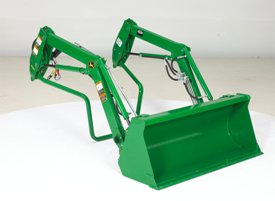 Quik-Park™ loader mounting system
Quik-Park™ loader mounting system

The Quik-Park mounting system on the 120R Loader is designed for easy removal and mounting to and from the tractor without tools.
Just like on the former H120, the parking stand is attached to the mast. To lower it into the park position, simply move the joystick to the raise position once the latches are opened.
 Easy removal and mounting (shown on a noncurrent 1026R)
Easy removal and mounting (shown on a noncurrent 1026R)
 Mount to and from the tractor without tools
Mount to and from the tractor without tools
D120
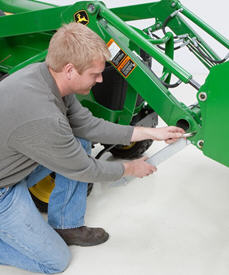
The D120 does not utilize the Quik-Park system as used on the 120R, but rather has two parking stands that are stored within the torque tube for a manual parking process.
Remove the parking stand from the torque tube area and place within the loader foot plate during the parking process (as shown).
Once the loader weight is being supported by the bucket and parking stands, manually remove the pins from the mast assembly and disconnect hydraulics.


After installing the parking stands, removing the parking pins and disconnecting hydraulics, simply back away.

End-of-pin lubrication on cylinder and pivot pins allows easy access for servicing grease points
 Pivot pin
Pivot pin
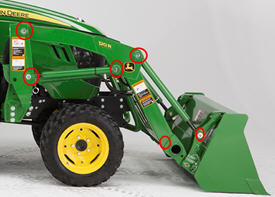 Pivot pins shown on the 120R Loader
Pivot pins shown on the 120R Loader
The unique offset head design eliminates cross-pins and cotter pins to retain the pin.
A nut ensures the pins remain in position.
A lubrication groove provides a path for lubrication.
End-of-pin lubrication allows easy access for servicing grease points, which are visible from the side of the loader.
Features
Engine
Our FT4/Stage IV diesels delivers generous displacement, power, and lugging ability.
Ash-service intervals for the diesel particulate filter (DPF) are condition based, so changing it may not be necessary until the first engine overhaul. Intervals can be extended further depending on application, regular maintenance practices, and the use of recommended fluids and lubricants.
Quad-Cool™
Quad-Cool places the radiator, air-conditioner condenser, intercooler, and hydraulic, transmission, and optional axle coolers in a unique boxed configuration that's isolated from engine heat.
Optional programmable fan reverses, ejecting debris from radiator and cooler cores.
Transmission and Axles
With ride control, the lift cylinders act as shock absorbers, cushioning bumps to allow these loaders to navigate rough ground more quickly without losing their loads.
Automatic differential lock engages as soon as a tire begins to slip. It's ideal for inexperienced operators or applications requiring high traction, such as stockpiling silage, plowing snow, and handling pipe.
Maintenance
Lockable compartment swings open wide, offering convenient ground-level access to remote-start battery terminals and the electrical-disconnect switch.
Conveniently located, easy-to-read sight gauges and see-through reservoirs let you check transmission, hydraulic, coolant, and windshield washer fluid levels at a glance.
Controls
Choose single-lever joystick or two-lever fingertip pilot-operated hydraulic controls.
Optional joystick steering is ideal for V-pattern truck loading.
Versatility
Equip your loader with optional Z-Bar, High Lift, Tool Carrier, or Parallel Lift linkage
Worksite Pro couplers make attachment switchover easy to get even more out of your machine.
Safety & Security
Sealed-switch module keeps out dust and moisture while eliminating nearly 100 wires. Prevent unauthorized machine operation with keyless-start requiring a numeric pass code.
Optional rearview camera and radar object-detection system
Features
Engine
644K Hybrid delivers up to 25-percent better average fuel efficiency than its conventional IT4 counterpart with a lockup torque converter. In applications such as V-pattern truck loading, fuel savings will be even larger.
EPA IT4/EU Stage IIIB 6.8-L diesel runs at a constant 900, 1,200, 1,500, or 1,800 rpm. Constant speed reduces engine wear, noise levels, and fuel consumption. Top speed provides maximum power and productivity, while the slower settings increase efficiency.
Hybrid-Electric Drive
Hybrid-electric drive smoothly and efficiently recaptures energy to slow the loader when the operator lets off the accelerator. This lessens the load on the engine and reduces fuel consumption.
Quad-Cool™
Quad-Cool places the radiator, air-conditioner condenser, intercooler, and hydraulic, transmission, and optional axle coolers in a unique boxed configuration that's isolated from engine heat.
Transmission
PowerShift™ transmission provides smooth moves through four forward speed ranges.
Maintenance
All daily service points, including fuel, are grouped on the left side for quick and convenient ground-level access. Sight gauges enable quick fluid-level checks.
Versatility
Equip your loader with optional Z-Bar, High Lift, Tool Carrier, or Parallel Lift linkages.
Worksite Pro couplers make attachment switchover easy to get even more out of your machine.
Safety & Security
Sealed-switch module keeps out dust and moisture while eliminating nearly 100 wires. Prevent unauthorized machine operation with keyless-start requiring a numeric pass code.
Optional rearview camera and radar object-detection system
Features
Engine
Our FT4/Stage IV diesels deliver the best combination of performance, efficiency, and reliability. They employ field-proven cooled exhaust gas recirculation (EGR), easy-to-maintain high-uptime exhaust filters, and selective catalytic reduction (SCR).
Quad-Cool™
Quad-Cool places the radiator, air-conditioner condenser, intercooler, and hydraulic, transmission, and optional axle coolers in a unique boxed configuration that's isolated from engine heat.
Optional programmable fan automatically reverses at predetermined intervals, ejecting debris from the radiator and cooler cores. Or set your own cleaning cycles through the monitor.
Transmission and Axles
With ride control, the lift cylinders act as shock absorbers, cushioning bumps to allow these loaders to navigate rough ground more quickly without losing their loads.
Automatic differential lock engages as soon as a tire begins to slip. It's ideal for inexperienced operators or applications requiring high traction, such as stockpiling silage, plowing snow, and handling pipe.
Maintenance
Hinged panel tilts away for quick ground-level access to both the fuel and diesel exhaust fluid (DEF) tanks, making refills convenient and easy.
All daily service points including fuel are grouped on the left side of the machine for quick and convenient access.
Controls
Choose single-lever joystick or two-lever fingertip pilot-operated hydraulic controls.
Linkage
Z-Bar linkages provide high bucket breakout forces, reliable rollback to carry loads without spilling, and solid transport stability. A standard pin-on coupler or an optional hi-vis coupler adds versatility, reduces costs in a variety of applications, enables faster cycle times, and lowers operating weights.
Safety & Security
Sealed-switch module keeps out dust and moisture while eliminating nearly 100 wires.
Prevent unauthorized machine operation with keyless-start requiring a numeric pass code.
Features
Engine
The EPA FT4/EU Stage IV engine employs field-proven cooled exhaust gas recirculation (EGR) for reducing NOX, and a diesel particulate filter and diesel oxidation catalyst to reduce particulate matter.
Ash-service intervals for the diesel particulate filter (DPF) are condition based, with the machine notifying the operator before service is required.
Highly efficient hydraulically driven fans run only as fast as needed, reducing noise, fuel consumption, and operating costs. The cooling systems keep things running cool, even in high-trash environments and high altitudes. Reversing option automatically back-blows cooler cores to keep them clean.
Controls
Ergonomically correct short-throw pilot levers provide smooth, predictable fingertip control with less movement and effort.
Push buttons in the right lever allow predictable control of auxiliary hydraulic flow for operating attachments. Optional sliding switch provides proportional speed control.
Press the power-boost button on the right-hand control for extra digging power. Power boost also kicks in automatically in boom-up/lifting functions.
Productivity
Three productivity modes allow you to choose the digging style that fits the job:
- High-productivity delivers more power and faster hydraulic response to move more material.
- Power delivers a balance of power, speed, and fuel economy for normal operation.
- Economy limits top speed and helps save fuel.
Visibility
New hood design, expanded front and side glass, narrow front cab posts, overhead glass, and numerous mirrors provide optimal visibility.
Serviceability
Swing open the side panels and you'll discover many of the numerous ways this excavator can minimize maintenance, increase uptime, and reduce daily operating costs.
Arm & Boom
A John Deere exclusive, three welded bulkheads within the boom resist torsional stress for amazing durability.
Features
Engine
The EPA FT4/EU Stage IV engine employs field-proven cooled exhaust gas recirculation (EGR) for reducing NOX, and a diesel particulate filter and diesel oxidation catalyst to reduce particulate matter.
Ash-service intervals for the diesel particulate filter (DPF) are condition based, with the machine notifying the operator before service is required.
Highly efficient hydraulically driven fans run only as fast as needed, reducing noise, fuel consumption, and operating costs. The cooling systems keep things running cool, even in high-trash environments and high altitudes. Reversing option automatically back-blows cooler cores to keep them clean.
Controls
Ergonomically correct short-throw pilot levers provide smooth, predictable fingertip control with less movement and effort.
Push buttons in the right lever allow predictable control of auxiliary hydraulic flow for operating attachments. Optional sliding switch provides proportional speed control.
Press the power-boost button on the right-hand control for extra digging power. Power boost also kicks in automatically in boom-up/lifting functions.
Productivity
Three productivity modes allow you to choose the digging style that fits the job:
- High-productivity delivers more power and faster hydraulic response to move more material.
- Power delivers a balance of power, speed, and fuel economy for normal operation.
- Economy limits top speed and helps save fuel.
Visibility
New hood design, expanded front and side glass, narrow front cab posts, overhead glass, and numerous mirrors provide optimal visibility.
Serviceability
Swing open the side panels and you'll discover many of the numerous ways this excavator can minimize maintenance, increase uptime, and reduce daily operating costs.
Arm & Boom
A John Deere exclusive, three welded bulkheads within the boom resist torsional stress for amazing durability.
Features
Engine
The EPA FT4/EU Stage IV engine employs field-proven cooled exhaust gas recirculation (EGR) for reducing NOX, and a diesel particulate filter and diesel oxidation catalyst to reduce particulate matter.
Ash-service intervals for the diesel particulate filter (DPF) are condition based, with the machine notifying the operator before service is required.
Highly efficient hydraulically driven fans run only as fast as needed, reducing noise, fuel consumption, and operating costs. The cooling systems keep things running cool, even in high-trash environments and high altitudes. Reversing option automatically back-blows cooler cores to keep them clean.
Controls
Ergonomically correct short-throw pilot levers provide smooth, predictable fingertip control with less movement and effort.
Push buttons in the right lever allow predictable control of auxiliary hydraulic flow for operating attachments. Optional sliding switch provides proportional speed control.
Press the power-boost button on the right-hand control for extra digging power. Power boost also kicks in automatically in boom-up/lifting functions.
Productivity
Three productivity modes allow you to choose the digging style that fits the job:
- High-productivity delivers more power and faster hydraulic response to move more material.
- Power delivers a balance of power, speed, and fuel economy for normal operation.
- Economy limits top speed and helps save fuel.
Visibility
New hood design, expanded front and side glass, narrow front cab posts, overhead glass, and numerous mirrors provide optimal visibility.
Serviceability
Swing open the side panels and you'll discover many of the numerous ways this excavator can minimize maintenance, increase uptime, and reduce daily operating costs.
Arm & Boom
A John Deere exclusive, three welded bulkheads within the boom resist torsional stress for amazing durability.
Features
Reduced tail swing design
Whether up against a wall or between a rock and a hard place, this close-quarter specialist makes it all look pretty easy.
Engine
FT4/Stage IV engine requires no diesel particulate filter (DPF). Extended service intervals help maximize uptime.
Highly efficient heavy-duty cooling system keeps things cool, even in tough environments or high altitudes. Cool-on-demand suction-type fan helps reduce material buildup and maintenance.
Controls
Ergonomically correct short-throw pilot levers provide smooth, precise fingertip control with less movement and effort. Optional sliding switch provides proportional speed control.
Press the power-boost button on the right-hand control for extra digging power. Power boost also kicks in automatically in boom-up/lifting functions.
Productivity
Three productivity modes allow you to choose the digging style that fits the job:
- High-productivity delivers more power and faster hydraulic response to move more material.
- Power delivers a balance of power, speed, and fuel economy for normal operation.
- Economy limits top speed and helps save fuel.
Visibility
New hood design, expanded front and side glass, narrow front cab posts, overhead glass, and numerous mirrors provide optimal visibility.
Serviceability
Vertical spin-on fuel and engine oil filters are positioned for convenient and simplified servicing.
Large fuel tanks and 500- 5,000 hour engine and hydraulic oil-service intervals decrease downtime for routine maintenance.
Arm & Boom
A John Deere exclusive, three welded bulkheads within the boom resist torsional stress for amazing durability.
Features
Engine
The EPA FT4/EU Stage IV engine employs field-proven cooled exhaust gas recirculation (EGR) for reducing NOX, and a diesel particulate filter and diesel oxidation catalyst to reduce particulate matter.
Ash-service intervals for the diesel particulate filter (DPF) are condition based, with the machine notifying the operator before service is required.
Highly efficient hydraulically driven fans run only as fast as needed, reducing noise, fuel consumption, and operating costs. The cooling systems keep things running cool, even in high-trash environments and high altitudes. Reversing option automatically back-blows cooler cores to keep them clean.
Controls
Ergonomically correct short-throw pilot levers provide smooth, predictable fingertip control with less movement and effort.
Push buttons in the right lever allow predictable control of auxiliary hydraulic flow for operating attachments. Optional sliding switch provides proportional speed control.
Productivity
Three productivity modes allow you to choose the digging style that fits the job:
- High-productivity delivers more power and faster hydraulic response to move more material.
- Power delivers a balance of power, speed, and fuel economy for normal operation.
- Economy limits top speed and helps save fuel.
Visibility
New hood design, expanded front and side glass, narrow front cab posts, overhead glass, and numerous mirrors provide optimal visibility.
Serviceability
Swing open the side panels and you'll discover many of the numerous ways this excavator can minimize maintenance, increase uptime, and reduce daily operating costs.
Arm & Boom
A John Deere exclusive, three welded bulkheads within the boom resist torsional stress for amazing durability.
Features
Engine
Redesigned 5.2-L 129-kW (173 net hp) diesel engine meets FT4 emission regulations without aftertreatment devices, for enhanced reliability.
Lightweight, split-type hood that allows wide-open access to the engine from the front and same-side filters and water separator at ground level simplify maintenance.
Controls
Ergonomically correct short-throw pilot levers provide smooth, predictable fingertip control with less movement and effort.
The F-N-R directional switch is now conveniently located on the left-hand pilot lever, making it easier to control the blade and stabilizer functions.
Productivity
Three productivity modes allow you to choose the digging style that fits the job:
- High-productivity delivers more power and faster hydraulic response to move more material.
- Power delivers a balance of power, speed, and fuel economy for normal operation.
- Economy limits top speed and helps save fuel.
Visibility
New hood design, expanded front and side glass, narrow front cab posts, overhead glass, and numerous mirrors provide optimal visibility.
Serviceability
Swing open the side panels on either side of the machine to provide even more wide-open access to components.
Arm & Boom
Mono boom delivers the reach and lift capacity you need for long-distance work. Or opt for a two-piece boom for added versatility.
A John Deere exclusive, three welded bulkheads within the boom resist torsional stress for amazing durability.
Features
Engine
The EPA FT4/EU Stage IV engine employs field-proven cooled exhaust gas recirculation (EGR) for reducing NOX, and a diesel particulate filter and diesel oxidation catalyst to reduce particulate matter.
Ash-service intervals for the diesel particulate filter (DPF) are condition based, with the machine notifying the operator before service is required.
Highly efficient hydraulically driven fans run only as fast as needed, reducing noise, fuel consumption, and operating costs. The cooling systems keep things running cool, even in high-trash environments and high altitudes. Reversing option automatically back-blows cooler cores to keep them clean.
Controls
Ergonomically correct short-throw pilot levers provide smooth, predictable fingertip control with less movement and effort.
Push buttons in the right lever allow predictable control of auxiliary hydraulic flow for operating attachments. Optional sliding switch provides proportional speed control.
Productivity
Three productivity modes allow you to choose the digging style that fits the job:
- High-productivity delivers more power and faster hydraulic response to move more material.
- Power delivers a balance of power, speed, and fuel economy for normal operation.
- Economy limits top speed and helps save fuel.
Visibility
New hood design, expanded front and side glass, narrow front cab posts, overhead glass, and numerous mirrors provide optimal visibility.
Serviceability
Swing open the side panels and you'll discover many of the numerous ways this excavator can minimize maintenance, increase uptime, and reduce daily operating costs.
Arm & Boom
A John Deere exclusive, three welded bulkheads within the boom resist torsional stress for amazing durability.
Features
Engine
The EPA FT4/EU Stage IV engine employs field-proven cooled exhaust gas recirculation (EGR) for reducing NOX, and a diesel particulate filter and diesel oxidation catalyst to reduce particulate matter.
Ash-service intervals for the diesel particulate filter (DPF) are condition based, with the machine notifying the operator before service is required.
Highly efficient hydraulically driven fans run only as fast as needed, reducing noise, fuel consumption, and operating costs. The cooling systems keep things running cool, even in high-trash environments and high altitudes. Reversing option automatically back-blows cooler cores to keep them clean.
Controls
Ergonomically correct short-throw pilot levers provide smooth, predictable fingertip control with less movement and effort.
Push buttons in the right lever allow predictable control of auxiliary hydraulic flow for operating attachments. Optional sliding switch provides proportional speed control.
Productivity
Three productivity modes allow you to choose the digging style that fits the job:
- High-productivity delivers more power and faster hydraulic response to move more material.
- Power delivers a balance of power, speed, and fuel economy for normal operation.
- Economy limits top speed and helps save fuel.
Visibility
New hood design, expanded front and side glass, narrow front cab posts, overhead glass, and numerous mirrors provide optimal visibility.
Serviceability
Swing open the side panels and you'll discover many of the numerous ways this excavator can minimize maintenance, increase uptime, and reduce daily operating costs.
Arm & Boom
A John Deere exclusive, three welded bulkheads within the boom resist torsional stress for amazing durability.
Features
Reduced tail swing design
Whether up against a wall or between a rock and a hard place, this close-quarter specialist makes it all look pretty easy.
Engine
FT4/Stage IV engine requires no diesel particulate filter (DPF). Extended service intervals help maximize uptime.
Highly efficient heavy-duty cooling system keeps things cool, even in tough environments or high altitudes. Cool-on-demand suction-type fan helps reduce material buildup and maintenance.
Controls
Ergonomically correct short-throw pilot levers provide smooth, precise fingertip control with less movement and effort. Optional sliding switch provides proportional speed control.
Press the power-boost button on the right-hand control for extra digging power. Power boost also kicks in automatically in boom-up/lifting functions.
Productivity
Three productivity modes allow you to choose the digging style that fits the job:
- High-productivity delivers more power and faster hydraulic response to move more material.
- Power delivers a balance of power, speed, and fuel economy for normal operation.
- Economy limits top speed and helps save fuel.
Visibility
New hood design, expanded front and side glass, narrow front cab posts, overhead glass, and numerous mirrors provide optimal visibility.
Serviceability
Vertical spin-on fuel and engine oil filters are positioned for convenient and simplified servicing.
Large fuel tanks and 500- 5,000 hour engine and hydraulic oil-service intervals decrease downtime for routine maintenance.
Arm & Boom
A John Deere exclusive, three welded bulkheads within the boom resist torsional stress for amazing durability.
Features
Engine
The EPA FT4/EU Stage IV engine employs field-proven cooled exhaust gas recirculation (EGR) for reducing NOX, and a diesel particulate filter and diesel oxidation catalyst to reduce particulate matter.
Ash-service intervals for the diesel particulate filter (DPF) are condition based, with the machine notifying the operator before service is required.
Highly efficient heavy-duty cooling system keeps things cool, even in tough environments or high altitudes. Cool-on-demand suction-type fan helps reduce material buildup and maintenance.
Controls
Ergonomically correct short-throw pilot levers provide smooth, precise fingertip control with less movement and effort. Optional sliding switch provides proportional speed control.
Press the power-boost button on the right-hand control for extra digging power. Power boost also kicks in automatically in boom-up/lifting functions.
Productivity
Three productivity modes allow you to choose the digging style that fits the job:
- High-productivity delivers more power and faster hydraulic response to move more material.
- Power delivers a balance of power, speed, and fuel economy for normal operation.
- Economy limits top speed and helps save fuel.
Serviceability
Wide expanse of front and side glass, narrow front cab posts, large tinted overhead hatch, and numerous mirrors provide virtually unrestricted all-around visibility.
Visibility
Large hinged doors provide wide-open access to service items. Lube banks, filters, and checkpoints are grouped for added convenience.
Arm & Boom
Durable booms, arms and mainframes are warranted for three years or 10,000 hours.
Features
Engine
The EPA FT4/EU Stage IV engine employs field-proven cooled exhaust gas recirculation (EGR) for reducing NOX, and a diesel particulate filter and diesel oxidation catalyst to reduce particulate matter.
Viscous fan continuously adjusts speed as necessary for effective cooling. Helps reduce noise and fuel consumption, too.
Controls
Ergonomically correct short-throw pilot levers increase control and minimize effort.
Productivity
Engine performance and hydraulic flow are perfectly balanced for predictable operation. Three productivity modes allow you to choose the digging style that fits the job. Select economy mode to reduce fuel usage and operating noise, while slightly limiting productivity. Select power mode for most normal conditions. Select high power mode to maximize productivity.
Visibility
Wide expanse of front and side glass, narrow front cab posts, large tinted overhead hatch, and numerous mirrors provide virtually unrestricted all-around visibility.
Visibility
Large hinged doors provide wide-open access to service items. Lube banks, filters, and checkpoints are grouped for added convenience.
Arm & Boom
A John Deere exclusive, three welded bulkheads within the boom resist torsional stress for amazing durability.
Features
Engine
The EPA FT4/EU Stage IV engine employs field-proven cooled exhaust gas recirculation (EGR) for reducing NOX, and a diesel particulate filter and diesel oxidation catalyst to reduce particulate matter.
Controls
Ergonomically correct short-throw pilot levers increase control and minimize effort.
Productivity
Engine performance and hydraulic flow are perfectly balanced for predictable operation. Three productivity modes allow you to choose the digging style that fits the job. Select economy mode to reduce fuel usage and operating noise, while slightly limiting productivity. Select power mode for most normal conditions. Select high power mode to maximize productivity.
Visibility
Wide expanse of front and side glass, narrow front cab posts, large tinted overhead hatch, and numerous mirrors provide virtually unrestricted all-around visibility.
Visibility
Large hinged doors provide wide-open access to service items. Lube banks, filters, and checkpoints are grouped for added convenience.
Arm & Boom
A John Deere exclusive, three welded bulkheads within the boom resist torsional stress for amazing durability.
Features
Engine
John Deere Power Systems 4.5L engines are designed with replaceable cylinder liners for superior cooling, reduced oil breakdown, and reduced ring wear. This means cooler engine components and longer life as compared to cast-in-block designs.
PowerShift™ Transmission
Standard John Deere PowerShift™ Transmission provides smooth, on-the-fly, clutch-free gear shifts.
PowerShift™ transmission provides on-the-go seemingly clutchless gear changes, for the operator.
Mechanical-Front-Wheel-Drive
True four-wheel drive on command. Standard limited-slip mechanical-front-wheel drive delivers superior traction in any ground condition. Engage momentary mechanical-front-wheel drive "on the fly" with the touch of a button on the new loader control.
Cab and Controls
L-Series pilot towers provide more legroom and additional space for transitioning between loader and backhoe operation. Palm-on-top loader-control grip makes operation even easier with integrated electric clutch disconnect and momentary MFWD.
Craning Capacity
An additional 10–15 percent increase in craning capacity is activated through Lift Mode at the push of a button on the convenient sealed switch module.
Ride Control
Ride control, front loader hydraulic cylinders act as a shock absorber, smoothing travel over rough terrain.
Easy Maintenance
Same-side, ground-level service points help speed daily checks and fills. Other common-sense features such as quick-change filters, extended service intervals, simple-to-read sight gauges, and easy-access grease zerks help increase uptime and lower daily operating costs.
Security
Machine-security system with touchpad passcode helps prevent unauthorized operation.
Features
Engine
John Deere Power Systems 4.5L engines are designed with replaceable cylinder liners for superior cooling, reduced oil breakdown, and reduced ring wear. This means cooler engine components and longer life as compared to cast-in-block designs.
PowerShift™ Transmission
Standard John Deere PowerShift™ Transmission provides smooth, on-the-fly, clutch-free gear shifts.
Mechanical-Front-Wheel-Drive
True four-wheel drive on command. Standard limited-slip mechanical-front-wheel drive delivers superior traction in any ground condition. Engage momentary mechanical-front-wheel drive "on the fly" with the touch of a button on the new loader control.
Cab and Controls
L-Series pilot towers provide more legroom and additional space for transitioning between loader and backhoe operation. Palm-on-top loader-control grip makes operation even easier with integrated electric clutch disconnect and momentary MFWD.
Craning Capacity
An additional 10–15 percent increase in craning capacity is activated through Lift Mode at the push of a button on the convenient sealed switch module.
Ride Control
Ride control, front loader hydraulic cylinders act as a shock absorber, smoothing travel over rough terrain.
Easy Maintenance
Same-side, ground-level service points help speed daily checks and fills. Other common-sense features such as quick-change filters, extended service intervals, simple-to-read sight gauges, and easy-access grease zerks help increase uptime and lower daily operating costs.
Security
Machine-security system with touchpad passcode helps prevent unauthorized operation.
Features
Engine
John Deere Power Systems 4.5L engines are designed with replaceable cylinder liners for superior cooling, reduced oil breakdown, and reduced ring wear. This means cooler engine components and longer life as compared to cast-in-block designs.
PowerShift™ Transmission
Standard John Deere PowerShift™ Transmission provides smooth, on-the-fly, clutch-free gear shifts.
Standard Side-Shift
Standard-equipped side-shift backhoes with vertical stabilizers can be offset up to 542 mm right or left of center, making them ideal for work in crowded urban areas and around obstacles.
Mechanical-Front-Wheel-Drive
True four-wheel drive on command. Standard limited-slip mechanical-front-wheel drive delivers superior traction in any ground condition. Engage momentary mechanical-front-wheel drive "on the fly" with the touch of a button on the new loader control.
Cab and Controls
L-Series pilot towers provide more legroom and additional space for transitioning between loader and backhoe operation. Palm-on-top loader-control grip makes operation even easier with integrated electric clutch disconnect and momentary MFWD.
Ride Control
Ride control, front loader hydraulic cylinders act as a shock absorber, smoothing travel over rough terrain.
Easy Maintenance
Same-side ground-level service points help speed daily checks and fills. Other common-sense features such as quick-change filters, extended service intervals, simple-to-read sight gauges, and easy-access grease zerks help increase uptime and lower daily operating costs.
Security
Machine-security system with touchpad passcode helps prevent unauthorized operation.
Features
Engine
John Deere Power Systems 4.5L engines are designed with replaceable cylinder liners for superior cooling, reduced oil breakdown, and reduced ring wear. This means cooler engine components and longer life as compared to cast-in-block designs.
PowerShift™ Transmission
Standard John Deere PowerShift™ Transmission provides smooth, on-the-fly, clutch-free gear shifts.
Mechanical-Front-Wheel-Drive
True four-wheel drive on command. Standard limited-slip mechanical-front-wheel drive delivers superior traction in any ground condition. Engage momentary mechanical-front-wheel drive “on the fly” with the touch of a button on the new loader control.
Cab and Controls
L-Series pilot towers provide more legroom and additional space for transitioning between loader and backhoe operation. Palm-on-top loader-control grip makes operation even easier with integrated electric clutch disconnect and momentary MFWD.
Craning Capacity
An additional 10–15 percent increase in craning capacity is activated through Lift Mode at the push of a button on the convenient sealed switch module.
Ride Control
Ride control, front loader hydraulic cylinders act as a shock absorber, smoothing travel over rough terrain.
Easy Maintenance
Same-side, ground-level service points help speed daily checks and fills. Other common-sense features such as quick-change filters, extended service intervals, simple-to-read sight gauges, and easy-access grease zerks help increase uptime and lower daily operating costs.
Security
Machine-security system with touchpad passcode helps prevent unauthorized operation.
Features
Engine
John Deere Power Systems 4.5L engines are designed with replaceable cylinder liners for superior cooling, reduced oil breakdown, and reduced ring wear. This means cooler engine components and longer life as compared to cast-in-block designs.
PowerShift™ Transmission
Standard John Deere PowerShift™ Transmission provides smooth, on-the-fly, clutch-free gear shifts.
Mechanical-Front-Wheel-Drive
True four-wheel drive on command. Standard limited-slip mechanical-front-wheel drive delivers superior traction in any ground condition. Engage momentary mechanical-front-wheel drive “on the fly” with the touch of a button on the new loader control.
Cab and Controls
L-Series pilot towers provide more legroom and additional space for transitioning between loader and backhoe operation. Palm-on-top loader-control grip makes operation even easier with integrated electric clutch disconnect and momentary MFWD.
Ride Control
Ride control, front loader hydraulic cylinders act as a shock absorber, smoothing travel over rough terrain.
Easy Maintenance
Same-side, ground-level service points help speed daily checks and fills. Other common-sense features such as quick-change filters, extended service intervals, simple-to-read sight gauges, and easy-access grease zerks help increase uptime and lower daily operating costs.
Security
Machine-security system with touchpad passcode helps prevent unauthorized operation.
Features
Engine
John Deere Power Systems 4.5L engines are designed with replaceable cylinder liners for superior cooling, reduced oil breakdown, and reduced ring wear. This means cooler engine components and longer life as compared to cast-in-block designs.
PowerShift™ Transmission
Standard John Deere PowerShift™ Transmission provides smooth, on-the-fly, clutch-free gear shifts.
Mechanical Front Wheel Drive
Optional limited slip MFWD delivers superior traction that delivers up to 65% of the available power to the wheel with the best grip. The axle design removes the need for 'breathers', eliminating the potential for contamination by dirt or water.
Cab and Controls
L-Series pilot towers provide more legroom and additional space for transitioning between loader and backhoe operation. Palm-on-top loader-control grip makes operation even easier with integrated electric clutch disconnect.
Ride Control
Ride control, front loader hydraulic cylinders act as a shock absorber, smoothing travel over rough terrain.
Easy Maintenance
Same-side, ground-level service points help speed daily checks and fills. Other common-sense features such as quick-change filters, extended service intervals, simple-to-read sight gauges, and easy-access grease zerks help increase uptime and lower daily operating costs.
Security
Machine-security system with touchpad passcode helps prevent unauthorized operation.
Features
Powerful air-cooled engine delivers power and reliability
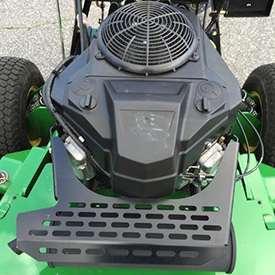 Air-cooled engine
Air-cooled engine
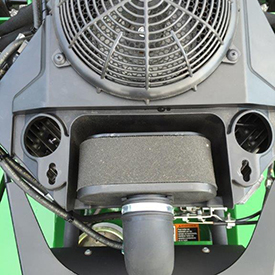 Engines have clean-out ports (SN 070001-)
Engines have clean-out ports (SN 070001-)
WHP36A Commercial Walk-Behind Mowers are powered by 14.5-hp (10.8-kW) air-cooled, vertical-shaft engines.
WHP48A and WHP52A Commercial Walk-Behind Mowers are powered by 18.5-hp (13.8-kW) air-cooled, vertical-shaft engines.
WHP61A Commercial Walk-Behind Mowers are powered by 23-hp (17.2-kW) air-cooled, vertical-shaft engines.
Engine features:
- Overhead valve design
- More horsepower and torque per cubic inch of displacement
- Better fuel efficiency
- Less oil consumption
- Cooler operating temperature
- Full-pressure lubrication with full-flow filter
- Reduces engine wear by ensuring proper lubrication, even when operating on hillsides or uneven terrain
- Helps keep oil clean for increased engine life
- V-twin design
- Air-cooled engine design
- Vertical shaft
- Dual-stage air cleaner for extended engine life and efficient operation
- Cylinder head clean-out ports to ease maintenance
- Electric start
- Fuel pump
- Complies with strict U.S. Environmental Protection Agency (EPA) and California Air Resources Board (CARB) emission standards without loss of horsepower or torque
- Consistently strong torque at low- or high-speed operation
- Aluminum-block engines
- Effectively dissipate heat
- Lightweight and strong construction
- Extend engine life due to elimination of debilitating engine temperatures
Field-installed propane conversion kits for Commercial Walk-Behind Mowers, QuikTrak™ Mowers, and Commercial ZTrak™ Mowers
 Propane conversion kit on a Walk-Behind Mower
Propane conversion kit on a Walk-Behind Mower
 Propane conversion kit on a ZTrak Mower
Propane conversion kit on a ZTrak Mower
John Deere provides application-specific Environmental Protection Agency (EPA) and California Air Resources Board (CARB) approved field-installed propane conversion kits for specific John Deere Commercial Walk-Behind Mowers, QuikTrak Mowers, and ZTrak Mowers. The conversion kits include all components required to convert the engines to operate on propane fuel. Single-tank or dual-tank brackets (depending on the vehicle) are provided for securely holding the propane tank(s) to the vehicle.
Propane tanks are not included.
An optional altitude kit is required when operating at altitudes above 2000 ft (610 m). The operator’s manual provided with the propane conversion kit provides further details. Parts must be ordered separately through John Deere Parts.
Propane facts:
- Propane is flammable and commonly used as a fuel.
- The molecular formula of propane is C3H8, and it is in the family of liquefied petroleum gases (LP gases). The other LP gases include butane, propylene, butadiene, butylene, isobutylene, and mixtures thereof.
- Propane is commonly available and has proven to be a dependable, safe, economical, and clean-burning fuel. It can be used as household fuel, industrial fuel, and fuel for internal combustion engines. Propane has been used as a fuel since 1910.
- At atmospheric pressure, propane boils at -44°F (-42.2°C), meaning it typically exists as a vapor. However, when contained under pressure, such as in a propane cylinder, it can exist as a liquid.
- Propane is naturally odorless, but includes an additive odorant, usually mercaptan, which gives it a distinct odor.
- Vapor propane is heavier than air, meaning it will settle in low areas such as along the ground or in drains.
Advantages of John Deere propane conversion kits include:
- Reduced fuel costs, up to 30 percent depending on fuel prices
- Lower emissions
- Reduced fuel-system maintenance
- Maintains John Deere warranty
- EPA and CARB certified
- May qualify for national and state rebate and incentive programs. Please visit www.propane.com/commercial-landscape/programs-and-incentives/ for further information.
Propane tank mounting bracket options:
 Single propane tank shown on QuikTrak Mower
Single propane tank shown on QuikTrak Mower
 Dual propane tanks shown on ZTrak Mower
Dual propane tanks shown on ZTrak Mower
Optional tank configurations and sizes are available to provide operators the ability to tailor for run time:
- Commercial Walk-Behind Mowers have only a single-tank mounting option.
- The single-tank bracket is designed for one 20-lb (9.1-kg) or 33-lb (15-kg) Worthington tank.
- Tank is not included.
- The single-tank bracket is designed for one 20-lb (9.1-kg) or 33-lb (15-kg) Worthington tank.
- QuikTrak Mowers have single-tank and dual-tank mounting options.
- The single-tank, right-side bracket is designed for one 33-lb (15-kg) Worthington tank.
- Tank is not included.
- The dual-tank brackets are designed for two 20-lb (9.1-kg) Worthington tanks.
- Tanks are not included.
- The single-tank, right-side bracket is designed for one 33-lb (15-kg) Worthington tank.
- ZTrak Mowers have single-tank and dual-tank mounting options.
- The single-tank, left-side bracket is designed for one 33-lb (15-kg) or 43-lb (19.5-kg) Worthington tank.
- Tank is not included.
- The dual-tank brackets are designed for two 33-lb (15-kg) Worthington tanks.
- Tanks are not included.
- ZTrak Mowers with dual-tank configurations are not compatible with any material collection systems.
NOTE: Reference the Propane and Attachment Compatibility Chart to determine tank configurations that are compatible.
Estimated run-time comparison
| Engine displacement | FS603cc | FS726cc | FX726cc | FX852cc |
| Average consumption (lb [kg]/hr) | 3.9 (1.8) | 4.2 (1.9) | 4.2 (1.9) | 5.8 (2.6) |
| Run time (hours) with 20-lb (9.1-kg) tank | 5.1 | 4.8 | 4.8 | 3.4 |
| Run time (hours) with 33.5-lb (15.2-kg) tank | Not available | 8.0 | 8.0 | 5.8 |
| Run time (hours) with 43.5-lb (19.7-kg) tank | Not available | 10.4 | 10.4 | 7.5 |
Field-installed propane conversion kit compatibility:
NOTE: Conversion to propane is not intended for units with engines having more than 250 hours of use.
Commercial Walk-Behind Mowers
| WG Series | WH Series | WHP Series | |||||||||
| Model | WG32A | WG36A | WG48A | WH36A | WH48A | WH52A | WH61A | WHP36A | WHP48A | WHP52A | WHP61A |
| Engine model | FS481V | FS481V | FS481V | FS481V | FS600V | FS600V | FS691V | FS481V | FS600V | FS600V | FS691V |
| Engine displacement | 603 cc | 603 cc | 603 cc | 603 cc | 603 cc | 603 cc | 726 cc | 603 cc | 603 cc | 603 cc | 726 cc |
| Propane kit model number | Not available | Not available | Not available | FS603cc | FS603cc | FS603cc | FS726cc | FS603cc | FS603cc | FS603cc | FS726cc |
QuikTrak Mowers
| E Series | M Series | R Series | |||||||
| Model | 652E | 636M | 648M | 652M | 648R | 652R | 652R EFI | 661R | 661R EFI |
| Engine model | FX691V | FS600V | FX691V | FX691V | FX691V | FX730V | ECV740 EFI | FX730V | ECV740 EFI |
| Engine displacement | 726 cc | 603 cc | 726 cc | 726 cc | 726 cc | 726 cc | 747 cc | 726 cc | 747 cc |
| Propane kit model number | FX726cc | Not available | Not available | Not available | FX726cc | FX726cc | Not available | FX726cc | Not available |
Commercial ZTrak Mowers
| E Series | M Series | R Series | |||||||||
| Model | Z915E | Z920M | Z925M FF | Z930M | Z945M EFI | Z950M | Z955M EFI | Z960M | Z930R | Z950R | Z970R |
| Engine model | CV742 | FX730V | FCV740 | FX801V | ECV850 EFI | FX850V | ECV860J EFI | FX921V | FX801V | FX850V | FX1000V |
| Engine displacement | 747 cc | 726 cc | 747 cc | 852 cc | 824 cc | 852 cc | 824 cc | 999 cc | 852 cc | 852 cc | 999 cc |
| Propane kit model number | Not available | FX726cc* | Not available | FX852cc* | Not available | FX852cc* | Not available | Not available | FX852cc* | FX852cc* | Not available |
Worthington tanks are manufactured by Worthington Industries, Inc.
Pistol-grip controls within comfortable reach
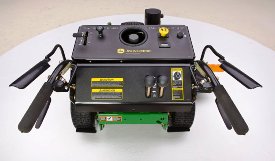 WHP Series operator controls (WHP48A shown)
WHP Series operator controls (WHP48A shown)

All of the controls on a WHP Series Mower are within comfortable reach of the operator.
The location and operation of the following controls on all models offer greater convenience, improved productivity, and increased safety:
- Operator presence system – the bails must be depressed to operate the unit; the machine must be in neutral and the power take-off (PTO) must be disengaged to start.
- Separate choke and throttle – this takes the guesswork out of choke operation, and there is less fouling of plugs.
- Pistol-grip controls – these controls are familiar to most operators and offer simplicity and reliability.
- Color-coded and clearly marked switches and buttons – these simplify operation.
- Bilingual decals – decals are provided in English and Spanish.
Self-propelled drive system provides infinite ground-speed adjustments to meet mowing needs
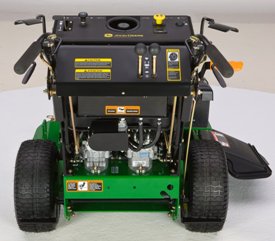 WHP Series drive system
WHP Series drive system

The WHP Series Mowers are equipped with an infinitely-variable hydrostatic drive system with reverse, which does the following:
- Provides infinite ground-speed adjustments - 0 mph to 7 mph (0 km/h to 11.3 km/h) to meet the mowing application
- Enables a smoother transition from one speed to another
- Gives a reverse speed of 3 mph (4.8 km/h), enabling the operator to back out of tight mowing areas and increase productivity
A 7-gauge, 0.179-in. (4.6-mm) fabricated floating mower deck delivers high-quality cut
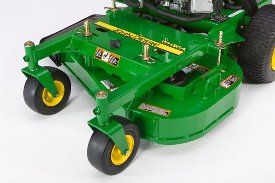 36-in. (91.4-cm) mower deck
36-in. (91.4-cm) mower deck
 52-in. (132.1-cm) mower deck
52-in. (132.1-cm) mower deck
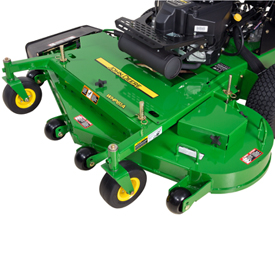 61-in. (155-cm) mower deck
61-in. (155-cm) mower deck

John Deere commercial mower decks have always demonstrated quality, performance, and durability. The 7-gauge, 0.179-in. (4.6-mm) fabricated floating mower deck delivers an extremely high-quality cut in diverse conditions.
Features:
- High blade-tip speed of 18,000 fpm (5,486 m/min) for more blade strikes per inch mowed
- Floating suspension to enable the best-possible cut
- Wide, raised discharge chute for more even clipping distribution
- Reinforced front lower edge for strength and durability
- Easy height-of-cut changes without tool
- Four, dual-captured, adjustable-height anti-scalp wheels
- Tube design with hanger brackets that provide a free-floating deck for smooth cut with reduced chance of scalping or scuffing by following the contour of the ground
- Easy-attach belt shields to allow quick access for service
- Wide, rolled lips for additional structural strength
- Greaseable spindles with easy top access for simplified servicing
- Two-coat paint covering to protect and resist corrosion
- Hardened steel blades that extend cutting time and increase durability
- Large discharge to evenly disperse expelled clippings
Flat-free front caster wheels eliminate downtime
 Front caster wheel
Front caster wheel
Rubber, wide-profile, flat-free front caster wheels provide a smooth cut.
Drive wheels provide excellent traction
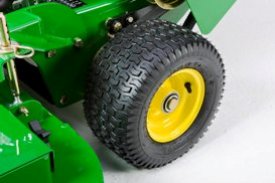 Mower drive wheel on WHP36A
Mower drive wheel on WHP36A
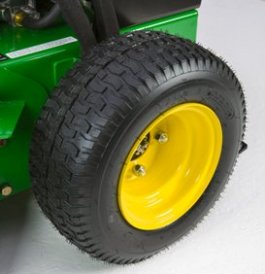 Mower drive wheel on WHP48A and WHP52A
Mower drive wheel on WHP48A and WHP52A
Wide and large drive wheels provide excellent traction with low turf compaction. They also provide maximum curb climbing. The square shoulder improves hillside performance.
The tire sizes for the WH Series models are as follows:
- WHP36A - 16x6.5x8-in. 4 PR
- WHP48A and WHP52A - 16x7.5x8-in. 4 PR
- WHP61A - 16x8.50-8 in. 4 PR
Exclusive two-year bumper-to-bumper warranty
An exclusive, two-year, single-source, bumper-to-bumper warranty is for all John Deere commercial mowing equipment. The warranty is best in class and places John Deere at the forefront of commercial mowing. It is hassle free, with one company handling all of the paperwork.
Features
Exclusive two-year bumper-to-bumper warranty
An exclusive, two-year, single-source, bumper-to-bumper warranty is for all John Deere commercial mowing equipment. The warranty is best in class and places John Deere at the forefront of commercial mowing. It is hassle free, with one company handling all of the paperwork.
Field-installed propane conversion kits for Commercial Walk-Behind Mowers, QuikTrak™ Mowers, and Commercial ZTrak™ Mowers
 Propane conversion kit on a Walk-Behind Mower
Propane conversion kit on a Walk-Behind Mower
 Propane conversion kit on a ZTrak Mower
Propane conversion kit on a ZTrak Mower
John Deere provides application-specific Environmental Protection Agency (EPA) and California Air Resources Board (CARB) approved field-installed propane conversion kits for specific John Deere Commercial Walk-Behind Mowers, QuikTrak Mowers, and ZTrak Mowers. The conversion kits include all components required to convert the engines to operate on propane fuel. Single-tank or dual-tank brackets (depending on the vehicle) are provided for securely holding the propane tank(s) to the vehicle.
Propane tanks are not included.
Optional altitude kit is required when operating at altitudes above 2000 ft (610 m). The operator’s manual provided with the propane conversion kit provides further details. Parts must be ordered separately through John Deere Parts.
Propane facts:
- Propane is flammable and commonly used as a fuel.
- The molecular formula of propane is C3H8, and it is in the family of liquefied petroleum gases (LP gases). The other LP gases include butane, propylene, butadiene, butylene, isobutylene, and mixtures thereof.
- Propane is commonly available and has proven to be a dependable, safe, economical, and clean-burning fuel. It can be used as household fuel, industrial fuel, and fuel for internal combustion engines. Propane has been used as a fuel since 1910.
- At atmospheric pressure, propane boils at -44°F (-42.2°C), meaning it typically exists as a vapor. However, when contained under pressure, such as in a propane cylinder, it can exist as a liquid.
- Propane is naturally odorless, but includes an additive odorant, usually mercaptan, which gives it a distinct odor.
- Vapor propane is heavier than air, meaning it will settle in low areas such as along the ground or in drains.
Advantages of John Deere propane conversion kits include:
- Reduced fuel costs, up to 30 percent depending on fuel prices
- Lower emissions
- Reduced fuel-system maintenance
- Maintains John Deere warranty
- EPA and CARB certified
- May qualify for national and state rebate and incentive programs. Please visit www.propane.com/commercial-landscape/programs-and-incentives/ for further information.
Propane tank mounting bracket options:
 Single propane tank shown on QuikTrak Mower
Single propane tank shown on QuikTrak Mower
 Dual propane tank shown on ZTrak Mower
Dual propane tank shown on ZTrak Mower
Optional tank and configurations and sizes are available to provide operators the ability to tailor for run time:
- Commercial Walk-Behind Mowers have only a single-tank mounting option.
- Single-tank bracket designed for one 20-lb (9.1-kg) or 33-lb (15-kg) Worthington tank.
- Tank is not included.
- Single-tank bracket designed for one 20-lb (9.1-kg) or 33-lb (15-kg) Worthington tank.
- QuikTrak Mowers have single-tank and dual-tank mounting options.
- Single-tank right-side bracket designed for one 33-lb (15-kg) Worthington tank.
- Tank is not included.
- Dual-tank brackets designed for two 20-lb (9.1-kg) Worthington tanks.
- Tanks are not included.
- Single-tank right-side bracket designed for one 33-lb (15-kg) Worthington tank.
- ZTrak Mowers have single-tank and dual-tank mounting options.
- Single-tank left-side bracket designed for one 33-lb (15-kg) or 43-lb (19.5-kg) Worthington tank.
- Tank is not included.
- Dual-tank brackets designed for two 33-lb (15-kg) Worthington tanks.
- Tanks are not included.
- ZTrak Mowers with dual-tank configurations are not compatible with any material collections system.
NOTE: Reference the “Propane and Attachment Compatibility Chart” to determine tank configurations that are compatible.
Estimated run time comparison
| Engine displacement | FS603cc | FS726cc | FX726cc | FX852cc |
| Average consumption (lb [kg]/hr) | 3.9 (1.8) | 4.2 (1.9) | 4.2 (1.9) | 5.8 (2.6) |
| Run time (hours) with 20-lb (9.1-kg) tank | 5.1 | 4.8 | 4.8 | 3.4 |
| Run time (hours) with 33.5-lb (15.2-kg) tank | Not available | 8.0 | 8.0 | 5.8 |
| Run time (hours) with 43.5-lb (19.7-kg) tank | Not available | 10.4 | 10.4 | 7.5 |
Field-installed propane conversion kit compatibility:
NOTE: Conversion to propane is not intended for units with engines having more than 250 hours of use.
Commercial Walk-Behind Mowers
| WG Series | WH Series | WHP Series | |||||||||
| Model | WG32A | WG36A | WG48A | WH36A | WH48A | WH52A | WH61A | WHP36A | WHP48A | WHP52A | WHP61A |
| Engine model | FS481V | FS481V | FS481V | FS481V | FS600V | FS600V | FS691V | FS481V | FS600V | FS600V | FS691V |
| Engine displacement | 603 cc | 603 cc | 603 cc | 603 cc | 603 cc | 603 cc | 726 cc | 603 cc | 603 cc | 603 cc | 726 cc |
| Propane kit model number | Not available | Not available | Not available | FS603cc | FS603cc | FS603cc | FS726cc | FS603cc | FS603cc | FS603cc | FS726cc |
QuikTrak Mowers
| E Series | M Series | R Series | |||||||
| Model | 652E | 636M | 648M | 652M | 648R | 652R | 652R EFI | 661R | 661R EFI |
| Engine model | FX691V | FS600V | FX691V | FX691V | FX691V | FX730V | ECV740 EFI | FX730V | ECV740 EFI |
| Engine displacement | 726 cc | 603 cc | 726 cc | 726 cc | 726 cc | 726 cc | 747 cc | 726 cc | 747 cc |
| Propane kit model number | FX726cc | Not available | Not available | Not available | FX726cc | FX726cc | Not available | FX726cc | Not available |
Commercial ZTrak Mowers
| E Series | M Series | R Series | ||||||||
| Model | Z915E | Z920M | Z925M FF | Z930M | Z930M EFI | Z950M | Z960M | Z930R | Z950R | Z970R |
| Engine model | CV742 | FX730V | FCV740 | FX801V | ECV749 | FX850V | FX921V | FX801V | FX850V | FX1000V |
| Engine displacement | 747 cc | 726 cc | 747 cc | 852 cc | 747 cc | 852 cc | 999 cc | 852 cc | 852 cc | 999 cc |
| Propane kit model number | Not available | FX726cc* | Not available | FX852cc* | Not available | FX852cc* | Not available | FX852cc* | FX852cc* | Not available |
Worthington tanks are manufactured by Worthington Industries, Inc.
Flat-free front caster wheels eliminate downtime
 Front caster wheel
Front caster wheel
Rubber, wide-profile, flat-free front caster wheels provide a smooth cut.
A 7-gauge, 0.179-in. (4.6-mm) fabricated floating mower deck delivers high-quality cut
 36-in. (91.4-cm) mower deck
36-in. (91.4-cm) mower deck
 52-in. (132.1-cm) mower deck
52-in. (132.1-cm) mower deck
 61-in. (155-cm) mower deck
61-in. (155-cm) mower deck

John Deere commercial mower decks have always demonstrated quality, performance, and durability. The 7-gauge, 0.179-in. (4.6-mm) fabricated floating mower deck delivers an extremely high-quality cut in diverse conditions.
Features:
- High blade-tip speed of 18,000 fpm (5,486 m/min) for more blade strikes per inch mowed
- Floating suspension to enable the best-possible cut
- Wide, raised discharge chute for more even clipping distribution
- Reinforced front lower edge for strength and durability
- Easy height-of-cut changes without tool
- Four, dual-captured, adjustable-height anti-scalp wheels
- Tube design with hanger brackets that provide a free-floating deck for smooth cut with reduced chance of scalping or scuffing by following the contour of the ground
- Easy-attach belt shields to allow quick access for service
- Wide, rolled lips for additional structural strength
- Greaseable spindles with easy top access for simplified servicing
- Two-coat paint covering to protect and resist corrosion
- Hardened steel blades that extend cutting time and increase durability
- Large discharge to evenly disperse expelled clippings
Pistol-grip controls within comfortable reach
 WHP Series operator controls (WHP48A shown)
WHP Series operator controls (WHP48A shown)

All of the controls on a WHP Series Mower are within comfortable reach of the operator.
The location and operation of the following controls on all models offer greater convenience, improved productivity, and increased safety:
- Operator presence system – the bails must be depressed to operate the unit; the machine must be in neutral and the power take-off (PTO) must be disengaged to start.
- Separate choke and throttle – this takes the guesswork out of choke operation, and there is less fouling of plugs.
- Pistol-grip controls – these controls are familiar to most operators and offer simplicity and reliability.
- Color-coded and clearly marked switches and buttons – these simplify operation.
- Bilingual decals – decals are provided in English and Spanish.
Self-propelled drive system provides infinite ground-speed adjustments to meet mowing needs
 WHP Series drive system
WHP Series drive system

The WHP Series Mowers are equipped with an infinitely-variable hydrostatic drive system with reverse, which does the following:
- Provides infinite ground-speed adjustments - 0 mph to 7 mph (0 km/h to 11.3 km/h) to meet the mowing application
- Enables a smoother transition from one speed to another
- Gives a reverse speed of 3 mph (4.8 km/h), enabling the operator to back out of tight mowing areas and increase productivity
Drive wheels provide excellent traction
 Mower drive wheel on WHP36A
Mower drive wheel on WHP36A
 Mower drive wheel on WHP48A and WHP52A
Mower drive wheel on WHP48A and WHP52A
Wide and large drive wheels provide excellent traction with low turf compaction. They also provide maximum curb climbing. The square shoulder improves hillside performance.
The tire sizes for the WH Series models are as follows:
- WHP36A - 16x6.5x8-in. 4 PR
- WHP48A and WHP52A - 16x7.5x8-in. 4 PR
- WHP61A - 16x8.50-8 in. 4 PR
Powerful air-cooled engine delivers power and reliability
 Air-cooled engine
Air-cooled engine
 Engines have clean-out ports (SN 070001-)
Engines have clean-out ports (SN 070001-)
WHP36A Commercial Walk-Behind Mowers are powered by 14.5-hp (10.8-kW) air-cooled, vertical-shaft engines.
WHP48A and WHP52A Commercial Walk-Behind Mowers are powered by 18.5-hp (13.8-kW) air-cooled, vertical-shaft engines.
WHP61A Commercial Walk-Behind Mowers are powered by 23-hp (17.2-kW) air-cooled, vertical-shaft engines.
Engine features:
- Overhead valve design
- More horsepower and torque per cubic inch of displacement
- Better fuel efficiency
- Less oil consumption
- Cooler operating temperature
- Full-pressure lubrication with full-flow filter
- Reduces engine wear by ensuring proper lubrication, even when operating on hillsides or uneven terrain
- Helps keep oil clean for increased engine life
- V-twin design
- Air-cooled engine design
- Vertical shaft
- Dual-stage air cleaner for extended engine life and efficient operation
- Cylinder head clean-out ports to ease maintenance
- Electric start
- Fuel pump
- Complies with strict U.S. Environmental Protection Agency (EPA) and California Air Resources Board (CARB) emission standards without loss of horsepower or torque
- Consistently strong torque at low- or high-speed operation
- Aluminum-block engines
- Effectively dissipate heat
- Lightweight and strong construction
- Extend engine life due to elimination of debilitating engine temperatures
Optional grass-collecting system makes collecting thatch and leaves easy
 Grass catcher
Grass catcher
A 3-cu ft (85-L) capacity grass catcher is available as an attachment for field conversion. Made of strong yet lightweight steel, the grass catcher provides an easy means for collecting thatch and leaves.
The grass-collecting system offers the following features:
- Catcher is designed with a large, 3-cu ft (85-L) capacity
- Bottom of the catcher is sloped at an angle for clearing hilly areas and ground obstacles
- Catcher is designed for quick and easy removal and installation
- Handles are large for sturdy gripping while removing and installing the bagger
Features
Exclusive two-year bumper-to-bumper warranty
An exclusive, two-year, single-source, bumper-to-bumper warranty is for all John Deere commercial mowing equipment. The warranty is best in class and places John Deere at the forefront of commercial mowing. It is hassle free, with one company handling all of the paperwork.
Field-installed propane conversion kits for Commercial Walk-Behind Mowers, QuikTrak™ Mowers, and Commercial ZTrak™ Mowers
 Propane conversion kit on a Walk-Behind Mower
Propane conversion kit on a Walk-Behind Mower
 Propane conversion kit on a ZTrak Mower
Propane conversion kit on a ZTrak Mower
John Deere provides application-specific Environmental Protection Agency (EPA) and California Air Resources Board (CARB) approved field-installed propane conversion kits for specific John Deere Commercial Walk-Behind Mowers, QuikTrak Mowers, and ZTrak Mowers. The conversion kits include all components required to convert the engines to operate on propane fuel. Single-tank or dual-tank brackets (depending on the vehicle) are provided for securely holding the propane tank(s) to the vehicle.
Propane tanks are not included.
Optional altitude kit is required when operating at altitudes above 2000 ft (610 m). The operator’s manual provided with the propane conversion kit provides further details. Parts must be ordered separately through John Deere Parts.
Propane facts:
- Propane is flammable and commonly used as a fuel.
- The molecular formula of propane is C3H8, and it is in the family of liquefied petroleum gases (LP gases). The other LP gases include butane, propylene, butadiene, butylene, isobutylene, and mixtures thereof.
- Propane is commonly available and has proven to be a dependable, safe, economical, and clean-burning fuel. It can be used as household fuel, industrial fuel, and fuel for internal combustion engines. Propane has been used as a fuel since 1910.
- At atmospheric pressure, propane boils at -44°F (-42.2°C), meaning it typically exists as a vapor. However, when contained under pressure, such as in a propane cylinder, it can exist as a liquid.
- Propane is naturally odorless, but includes an additive odorant, usually mercaptan, which gives it a distinct odor.
- Vapor propane is heavier than air, meaning it will settle in low areas such as along the ground or in drains.
Advantages of John Deere propane conversion kits include:
- Reduced fuel costs, up to 30 percent depending on fuel prices
- Lower emissions
- Reduced fuel-system maintenance
- Maintains John Deere warranty
- EPA and CARB certified
- May qualify for national and state rebate and incentive programs. Please visit www.propane.com/commercial-landscape/programs-and-incentives/ for further information.
Propane tank mounting bracket options:
 Single propane tank shown on QuikTrak Mower
Single propane tank shown on QuikTrak Mower
 Dual propane tank shown on ZTrak Mower
Dual propane tank shown on ZTrak Mower
Optional tank and configurations and sizes are available to provide operators the ability to tailor for run time:
- Commercial Walk-Behind Mowers have only a single-tank mounting option.
- Single-tank bracket designed for one 20-lb (9.1-kg) or 33-lb (15-kg) Worthington tank.
- Tank is not included.
- Single-tank bracket designed for one 20-lb (9.1-kg) or 33-lb (15-kg) Worthington tank.
- QuikTrak Mowers have single-tank and dual-tank mounting options.
- Single-tank right-side bracket designed for one 33-lb (15-kg) Worthington tank.
- Tank is not included.
- Dual-tank brackets designed for two 20-lb (9.1-kg) Worthington tanks.
- Tanks are not included.
- Single-tank right-side bracket designed for one 33-lb (15-kg) Worthington tank.
- ZTrak Mowers have single-tank and dual-tank mounting options.
- Single-tank left-side bracket designed for one 33-lb (15-kg) or 43-lb (19.5-kg) Worthington tank.
- Tank is not included.
- Dual-tank brackets designed for two 33-lb (15-kg) Worthington tanks.
- Tanks are not included.
- ZTrak Mowers with dual-tank configurations are not compatible with any material collections system.
NOTE: Reference the “Propane and Attachment Compatibility Chart” to determine tank configurations that are compatible.
Estimated run time comparison
| Engine displacement | FS603cc | FS726cc | FX726cc | FX852cc |
| Average consumption (lb [kg]/hr) | 3.9 (1.8) | 4.2 (1.9) | 4.2 (1.9) | 5.8 (2.6) |
| Run time (hours) with 20-lb (9.1-kg) tank | 5.1 | 4.8 | 4.8 | 3.4 |
| Run time (hours) with 33.5-lb (15.2-kg) tank | Not available | 8.0 | 8.0 | 5.8 |
| Run time (hours) with 43.5-lb (19.7-kg) tank | Not available | 10.4 | 10.4 | 7.5 |
Field-installed propane conversion kit compatibility:
NOTE: Conversion to propane is not intended for units with engines having more than 250 hours of use.
Commercial Walk-Behind Mowers
| WG Series | WH Series | WHP Series | |||||||||
| Model | WG32A | WG36A | WG48A | WH36A | WH48A | WH52A | WH61A | WHP36A | WHP48A | WHP52A | WHP61A |
| Engine model | FS481V | FS481V | FS481V | FS481V | FS600V | FS600V | FS691V | FS481V | FS600V | FS600V | FS691V |
| Engine displacement | 603 cc | 603 cc | 603 cc | 603 cc | 603 cc | 603 cc | 726 cc | 603 cc | 603 cc | 603 cc | 726 cc |
| Propane kit model number | Not available | Not available | Not available | FS603cc | FS603cc | FS603cc | FS726cc | FS603cc | FS603cc | FS603cc | FS726cc |
QuikTrak Mowers
| E Series | M Series | R Series | |||||||
| Model | 652E | 636M | 648M | 652M | 648R | 652R | 652R EFI | 661R | 661R EFI |
| Engine model | FX691V | FS600V | FX691V | FX691V | FX691V | FX730V | ECV740 EFI | FX730V | ECV740 EFI |
| Engine displacement | 726 cc | 603 cc | 726 cc | 726 cc | 726 cc | 726 cc | 747 cc | 726 cc | 747 cc |
| Propane kit model number | FX726cc | Not available | Not available | Not available | FX726cc | FX726cc | Not available | FX726cc | Not available |
Commercial ZTrak Mowers
| E Series | M Series | R Series | ||||||||
| Model | Z915E | Z920M | Z925M FF | Z930M | Z930M EFI | Z950M | Z960M | Z930R | Z950R | Z970R |
| Engine model | CV742 | FX730V | FCV740 | FX801V | ECV749 | FX850V | FX921V | FX801V | FX850V | FX1000V |
| Engine displacement | 747 cc | 726 cc | 747 cc | 852 cc | 747 cc | 852 cc | 999 cc | 852 cc | 852 cc | 999 cc |
| Propane kit model number | Not available | FX726cc* | Not available | FX852cc* | Not available | FX852cc* | Not available | FX852cc* | FX852cc* | Not available |
Worthington tanks are manufactured by Worthington Industries, Inc.
Flat-free front caster wheels eliminate downtime
 Front caster wheel
Front caster wheel
Rubber, wide-profile, flat-free front caster wheels provide a smooth cut.
A 7-gauge, 0.179-in. (4.6-mm) fabricated floating mower deck delivers high-quality cut
 36-in. (91.4-cm) mower deck
36-in. (91.4-cm) mower deck
 52-in. (132.1-cm) mower deck
52-in. (132.1-cm) mower deck
 61-in. (155-cm) mower deck
61-in. (155-cm) mower deck

John Deere commercial mower decks have always demonstrated quality, performance, and durability. The 7-gauge, 0.179-in. (4.6-mm) fabricated floating mower deck delivers an extremely high-quality cut in diverse conditions.
Features:
- High blade-tip speed of 18,000 fpm (5,486 m/min) for more blade strikes per inch mowed
- Floating suspension to enable the best-possible cut
- Wide, raised discharge chute for more even clipping distribution
- Reinforced front lower edge for strength and durability
- Easy height-of-cut changes without tool
- Four, dual-captured, adjustable-height anti-scalp wheels
- Tube design with hanger brackets that provide a free-floating deck for smooth cut with reduced chance of scalping or scuffing by following the contour of the ground
- Easy-attach belt shields to allow quick access for service
- Wide, rolled lips for additional structural strength
- Greaseable spindles with easy top access for simplified servicing
- Two-coat paint covering to protect and resist corrosion
- Hardened steel blades that extend cutting time and increase durability
- Large discharge to evenly disperse expelled clippings
Pistol-grip controls within comfortable reach
 WHP Series operator controls (WHP48A shown)
WHP Series operator controls (WHP48A shown)

All of the controls on a WHP Series Mower are within comfortable reach of the operator.
The location and operation of the following controls on all models offer greater convenience, improved productivity, and increased safety:
- Operator presence system – the bails must be depressed to operate the unit; the machine must be in neutral and the power take-off (PTO) must be disengaged to start.
- Separate choke and throttle – this takes the guesswork out of choke operation, and there is less fouling of plugs.
- Pistol-grip controls – these controls are familiar to most operators and offer simplicity and reliability.
- Color-coded and clearly marked switches and buttons – these simplify operation.
- Bilingual decals – decals are provided in English and Spanish.
Self-propelled drive system provides infinite ground-speed adjustments to meet mowing needs
 WHP Series drive system
WHP Series drive system

The WHP Series Mowers are equipped with an infinitely-variable hydrostatic drive system with reverse, which does the following:
- Provides infinite ground-speed adjustments - 0 mph to 7 mph (0 km/h to 11.3 km/h) to meet the mowing application
- Enables a smoother transition from one speed to another
- Gives a reverse speed of 3 mph (4.8 km/h), enabling the operator to back out of tight mowing areas and increase productivity
Drive wheels provide excellent traction
 Mower drive wheel on WHP36A
Mower drive wheel on WHP36A
 Mower drive wheel on WHP48A and WHP52A
Mower drive wheel on WHP48A and WHP52A
Wide and large drive wheels provide excellent traction with low turf compaction. They also provide maximum curb climbing. The square shoulder improves hillside performance.
The tire sizes for the WH Series models are as follows:
- WHP36A - 16x6.5x8-in. 4 PR
- WHP48A and WHP52A - 16x7.5x8-in. 4 PR
- WHP61A - 16x8.50-8 in. 4 PR
Powerful air-cooled engine delivers power and reliability
 Air-cooled engine
Air-cooled engine
 Engines have clean-out ports (SN 070001-)
Engines have clean-out ports (SN 070001-)
WHP36A Commercial Walk-Behind Mowers are powered by 14.5-hp (10.8-kW) air-cooled, vertical-shaft engines.
WHP48A and WHP52A Commercial Walk-Behind Mowers are powered by 18.5-hp (13.8-kW) air-cooled, vertical-shaft engines.
WHP61A Commercial Walk-Behind Mowers are powered by 23-hp (17.2-kW) air-cooled, vertical-shaft engines.
Engine features:
- Overhead valve design
- More horsepower and torque per cubic inch of displacement
- Better fuel efficiency
- Less oil consumption
- Cooler operating temperature
- Full-pressure lubrication with full-flow filter
- Reduces engine wear by ensuring proper lubrication, even when operating on hillsides or uneven terrain
- Helps keep oil clean for increased engine life
- V-twin design
- Air-cooled engine design
- Vertical shaft
- Dual-stage air cleaner for extended engine life and efficient operation
- Cylinder head clean-out ports to ease maintenance
- Electric start
- Fuel pump
- Complies with strict U.S. Environmental Protection Agency (EPA) and California Air Resources Board (CARB) emission standards without loss of horsepower or torque
- Consistently strong torque at low- or high-speed operation
- Aluminum-block engines
- Effectively dissipate heat
- Lightweight and strong construction
- Extend engine life due to elimination of debilitating engine temperatures
Optional grass-collecting system makes collecting thatch and leaves easy
 Grass catcher
Grass catcher
A 3-cu ft (85-L) capacity grass catcher is available as an attachment for field conversion. Made of strong yet lightweight steel, the grass catcher provides an easy means for collecting thatch and leaves.
The grass-collecting system offers the following features:
- Catcher is designed with a large, 3-cu ft (85-L) capacity
- Bottom of the catcher is sloped at an angle for clearing hilly areas and ground obstacles
- Catcher is designed for quick and easy removal and installation
- Handles are large for sturdy gripping while removing and installing the bagger
Features
Powerful air-cooled engine delivers power and reliability
 Air-cooled engine
Air-cooled engine
 Engines have clean-out ports (SN 070001-)
Engines have clean-out ports (SN 070001-)
WHP36A Commercial Walk-Behind Mowers are powered by 14.5-hp (10.8-kW) air-cooled, vertical-shaft engines.
WHP48A and WHP52A Commercial Walk-Behind Mowers are powered by 18.5-hp (13.8-kW) air-cooled, vertical-shaft engines.
WHP61A Commercial Walk-Behind Mowers are powered by 23-hp (17.2-kW) air-cooled, vertical-shaft engines.
Engine features:
- Overhead valve design
- More horsepower and torque per cubic inch of displacement
- Better fuel efficiency
- Less oil consumption
- Cooler operating temperature
- Full-pressure lubrication with full-flow filter
- Reduces engine wear by ensuring proper lubrication, even when operating on hillsides or uneven terrain
- Helps keep oil clean for increased engine life
- V-twin design
- Air-cooled engine design
- Vertical shaft
- Dual-stage air cleaner for extended engine life and efficient operation
- Cylinder head clean-out ports to ease maintenance
- Electric start
- Fuel pump
- Complies with strict U.S. Environmental Protection Agency (EPA) and California Air Resources Board (CARB) emission standards without loss of horsepower or torque
- Consistently strong torque at low- or high-speed operation
- Aluminum-block engines
- Effectively dissipate heat
- Lightweight and strong construction
- Extend engine life due to elimination of debilitating engine temperatures
Field-installed propane conversion kits for Commercial Walk-Behind Mowers, QuikTrak™ Mowers, and Commercial ZTrak™ Mowers
 Propane conversion kit on a Walk-Behind Mower
Propane conversion kit on a Walk-Behind Mower
 Propane conversion kit on a ZTrak Mower
Propane conversion kit on a ZTrak Mower
John Deere provides application-specific Environmental Protection Agency (EPA) and California Air Resources Board (CARB) approved field-installed propane conversion kits for specific John Deere Commercial Walk-Behind Mowers, QuikTrak Mowers, and ZTrak Mowers. The conversion kits include all components required to convert the engines to operate on propane fuel. Single-tank or dual-tank brackets (depending on the vehicle) are provided for securely holding the propane tank(s) to the vehicle.
Propane tanks are not included.
An optional altitude kit is required when operating at altitudes above 2000 ft (610 m). The operator’s manual provided with the propane conversion kit provides further details. Parts must be ordered separately through John Deere Parts.
Propane facts:
- Propane is flammable and commonly used as a fuel.
- The molecular formula of propane is C3H8, and it is in the family of liquefied petroleum gases (LP gases). The other LP gases include butane, propylene, butadiene, butylene, isobutylene, and mixtures thereof.
- Propane is commonly available and has proven to be a dependable, safe, economical, and clean-burning fuel. It can be used as household fuel, industrial fuel, and fuel for internal combustion engines. Propane has been used as a fuel since 1910.
- At atmospheric pressure, propane boils at -44°F (-42.2°C), meaning it typically exists as a vapor. However, when contained under pressure, such as in a propane cylinder, it can exist as a liquid.
- Propane is naturally odorless, but includes an additive odorant, usually mercaptan, which gives it a distinct odor.
- Vapor propane is heavier than air, meaning it will settle in low areas such as along the ground or in drains.
Advantages of John Deere propane conversion kits include:
- Reduced fuel costs, up to 30 percent depending on fuel prices
- Lower emissions
- Reduced fuel-system maintenance
- Maintains John Deere warranty
- EPA and CARB certified
- May qualify for national and state rebate and incentive programs. Please visit www.propane.com/commercial-landscape/programs-and-incentives/ for further information.
Propane tank mounting bracket options:
 Single propane tank shown on QuikTrak Mower
Single propane tank shown on QuikTrak Mower
 Dual propane tanks shown on ZTrak Mower
Dual propane tanks shown on ZTrak Mower
Optional tank configurations and sizes are available to provide operators the ability to tailor for run time:
- Commercial Walk-Behind Mowers have only a single-tank mounting option.
- The single-tank bracket is designed for one 20-lb (9.1-kg) or 33-lb (15-kg) Worthington tank.
- Tank is not included.
- The single-tank bracket is designed for one 20-lb (9.1-kg) or 33-lb (15-kg) Worthington tank.
- QuikTrak Mowers have single-tank and dual-tank mounting options.
- The single-tank, right-side bracket is designed for one 33-lb (15-kg) Worthington tank.
- Tank is not included.
- The dual-tank brackets are designed for two 20-lb (9.1-kg) Worthington tanks.
- Tanks are not included.
- The single-tank, right-side bracket is designed for one 33-lb (15-kg) Worthington tank.
- ZTrak Mowers have single-tank and dual-tank mounting options.
- The single-tank, left-side bracket is designed for one 33-lb (15-kg) or 43-lb (19.5-kg) Worthington tank.
- Tank is not included.
- The dual-tank brackets are designed for two 33-lb (15-kg) Worthington tanks.
- Tanks are not included.
- ZTrak Mowers with dual-tank configurations are not compatible with any material collection systems.
NOTE: Reference the Propane and Attachment Compatibility Chart to determine tank configurations that are compatible.
Estimated run-time comparison
| Engine displacement | FS603cc | FS726cc | FX726cc | FX852cc |
| Average consumption (lb [kg]/hr) | 3.9 (1.8) | 4.2 (1.9) | 4.2 (1.9) | 5.8 (2.6) |
| Run time (hours) with 20-lb (9.1-kg) tank | 5.1 | 4.8 | 4.8 | 3.4 |
| Run time (hours) with 33.5-lb (15.2-kg) tank | Not available | 8.0 | 8.0 | 5.8 |
| Run time (hours) with 43.5-lb (19.7-kg) tank | Not available | 10.4 | 10.4 | 7.5 |
Field-installed propane conversion kit compatibility:
NOTE: Conversion to propane is not intended for units with engines having more than 250 hours of use.
Commercial Walk-Behind Mowers
| WG Series | WH Series | WHP Series | |||||||||
| Model | WG32A | WG36A | WG48A | WH36A | WH48A | WH52A | WH61A | WHP36A | WHP48A | WHP52A | WHP61A |
| Engine model | FS481V | FS481V | FS481V | FS481V | FS600V | FS600V | FS691V | FS481V | FS600V | FS600V | FS691V |
| Engine displacement | 603 cc | 603 cc | 603 cc | 603 cc | 603 cc | 603 cc | 726 cc | 603 cc | 603 cc | 603 cc | 726 cc |
| Propane kit model number | Not available | Not available | Not available | FS603cc | FS603cc | FS603cc | FS726cc | FS603cc | FS603cc | FS603cc | FS726cc |
QuikTrak Mowers
| E Series | M Series | R Series | |||||||
| Model | 652E | 636M | 648M | 652M | 648R | 652R | 652R EFI | 661R | 661R EFI |
| Engine model | FX691V | FS600V | FX691V | FX691V | FX691V | FX730V | ECV740 EFI | FX730V | ECV740 EFI |
| Engine displacement | 726 cc | 603 cc | 726 cc | 726 cc | 726 cc | 726 cc | 747 cc | 726 cc | 747 cc |
| Propane kit model number | FX726cc | Not available | Not available | Not available | FX726cc | FX726cc | Not available | FX726cc | Not available |
Commercial ZTrak Mowers
| E Series | M Series | R Series | |||||||||
| Model | Z915E | Z920M | Z925M FF | Z930M | Z945M EFI | Z950M | Z955M EFI | Z960M | Z930R | Z950R | Z970R |
| Engine model | CV742 | FX730V | FCV740 | FX801V | ECV850 EFI | FX850V | ECV860J EFI | FX921V | FX801V | FX850V | FX1000V |
| Engine displacement | 747 cc | 726 cc | 747 cc | 852 cc | 824 cc | 852 cc | 824 cc | 999 cc | 852 cc | 852 cc | 999 cc |
| Propane kit model number | Not available | FX726cc* | Not available | FX852cc* | Not available | FX852cc* | Not available | Not available | FX852cc* | FX852cc* | Not available |
Worthington tanks are manufactured by Worthington Industries, Inc.
Pistol-grip controls within comfortable reach
 WHP Series operator controls (WHP48A shown)
WHP Series operator controls (WHP48A shown)

All of the controls on a WHP Series Mower are within comfortable reach of the operator.
The location and operation of the following controls on all models offer greater convenience, improved productivity, and increased safety:
- Operator presence system – the bails must be depressed to operate the unit; the machine must be in neutral and the power take-off (PTO) must be disengaged to start.
- Separate choke and throttle – this takes the guesswork out of choke operation, and there is less fouling of plugs.
- Pistol-grip controls – these controls are familiar to most operators and offer simplicity and reliability.
- Color-coded and clearly marked switches and buttons – these simplify operation.
- Bilingual decals – decals are provided in English and Spanish.
Self-propelled drive system provides infinite ground-speed adjustments to meet mowing needs
 WHP Series drive system
WHP Series drive system

The WHP Series Mowers are equipped with an infinitely-variable hydrostatic drive system with reverse, which does the following:
- Provides infinite ground-speed adjustments - 0 mph to 7 mph (0 km/h to 11.3 km/h) to meet the mowing application
- Enables a smoother transition from one speed to another
- Gives a reverse speed of 3 mph (4.8 km/h), enabling the operator to back out of tight mowing areas and increase productivity
A 7-gauge, 0.179-in. (4.6-mm) fabricated floating mower deck delivers high-quality cut
 36-in. (91.4-cm) mower deck
36-in. (91.4-cm) mower deck
 52-in. (132.1-cm) mower deck
52-in. (132.1-cm) mower deck
 61-in. (155-cm) mower deck
61-in. (155-cm) mower deck

John Deere commercial mower decks have always demonstrated quality, performance, and durability. The 7-gauge, 0.179-in. (4.6-mm) fabricated floating mower deck delivers an extremely high-quality cut in diverse conditions.
Features:
- High blade-tip speed of 18,000 fpm (5,486 m/min) for more blade strikes per inch mowed
- Floating suspension to enable the best-possible cut
- Wide, raised discharge chute for more even clipping distribution
- Reinforced front lower edge for strength and durability
- Easy height-of-cut changes without tool
- Four, dual-captured, adjustable-height anti-scalp wheels
- Tube design with hanger brackets that provide a free-floating deck for smooth cut with reduced chance of scalping or scuffing by following the contour of the ground
- Easy-attach belt shields to allow quick access for service
- Wide, rolled lips for additional structural strength
- Greaseable spindles with easy top access for simplified servicing
- Two-coat paint covering to protect and resist corrosion
- Hardened steel blades that extend cutting time and increase durability
- Large discharge to evenly disperse expelled clippings
Flat-free front caster wheels eliminate downtime
 Front caster wheel
Front caster wheel
Rubber, wide-profile, flat-free front caster wheels provide a smooth cut.
Drive wheels provide excellent traction
 Mower drive wheel on WHP36A
Mower drive wheel on WHP36A
 Mower drive wheel on WHP48A and WHP52A
Mower drive wheel on WHP48A and WHP52A
Wide and large drive wheels provide excellent traction with low turf compaction. They also provide maximum curb climbing. The square shoulder improves hillside performance.
The tire sizes for the WH Series models are as follows:
- WHP36A - 16x6.5x8-in. 4 PR
- WHP48A and WHP52A - 16x7.5x8-in. 4 PR
- WHP61A - 16x8.50-8 in. 4 PR
Optional grass-collecting system makes collecting thatch and leaves easy
 Grass catcher
Grass catcher
A 3-cu ft (85-L) capacity grass catcher is available as an attachment for field conversion. Made of strong yet lightweight steel, the grass catcher provides an easy means for collecting thatch and leaves.
The grass-collecting system offers the following features:
- Catcher is designed with a large, 3-cu ft (85-L) capacity
- Bottom of the catcher is sloped at an angle for clearing hilly areas and ground obstacles
- Catcher is designed for quick and easy removal and installation
- Handles are large for sturdy gripping while removing and installing the bagger
Exclusive two-year bumper-to-bumper warranty
An exclusive, two-year, single-source, bumper-to-bumper warranty is for all John Deere commercial mowing equipment. The warranty is best in class and places John Deere at the forefront of commercial mowing. It is hassle free, with one company handling all of the paperwork.
Features
Powerful air-cooled engine delivers power and reliability
 Air-cooled engine
Air-cooled engine
 Engines have clean-out ports (SN 070001-)
Engines have clean-out ports (SN 070001-)
WH36A Commercial Walk-Behind Mower is powered by a 14.5-hp (10.8-kW) air-cooled, vertical-shaft engine.
WH48A and WH52A Commercial Walk-Behind Mowers are powered by 18.5-hp (13.8-kW) air-cooled, vertical-shaft engines.
WH61A Commercial Walk-Behind Mower is powered by a 23-hp (17.2-kW) air-cooled, vertical-shaft engine.
Engine features:
- Overhead valve design
- More horsepower and torque per cubic inch of displacement
- Better fuel efficiency
- Less oil consumption
- Cooler operating temperature
- Full-pressure lubrication with full-flow filter
- Reduces engine wear by ensuring proper lubrication, even when operating on hillsides or uneven terrain
- Helps keep oil clean for increased engine life
- V-twin design
- Air-cooled engine design
- Vertical shaft
- Dual-stage air cleaner for extended engine life and efficient operation
- Cylinder head clean-out ports to ease maintenance
- Electric start
- Fuel pump
- Complies with strict U.S. Environmental Protection Agency (EPA) and California Air Resources Board (CARB) emission standards without loss of horsepower or torque
- Consistently strong torque at low- or high-speed operation
- Aluminum block engines
- Effectively dissipate heat
- Lightweight and strong construction
- Extend engine life due to elimination of debilitating engine temperatures
Field-installed propane conversion kits for Commercial Walk-Behind Mowers, QuikTrak™ Mowers, and Commercial ZTrak™ Mowers
 Propane conversion kit on a Walk-Behind Mower
Propane conversion kit on a Walk-Behind Mower
 Propane conversion kit on a ZTrak Mower
Propane conversion kit on a ZTrak Mower
John Deere provides application-specific Environmental Protection Agency (EPA) and California Air Resources Board (CARB) approved field-installed propane conversion kits for specific John Deere Commercial Walk-Behind Mowers, QuikTrak Mowers, and ZTrak Mowers. The conversion kits include all components required to convert the engines to operate on propane fuel. Single-tank or dual-tank brackets (depending on the vehicle) are provided for securely holding the propane tank(s) to the vehicle.
Propane tanks are not included.
An optional altitude kit is required when operating at altitudes above 2000 ft (610 m). The operator’s manual provided with the propane conversion kit provides further details. Parts must be ordered separately through John Deere Parts.
Propane facts:
- Propane is flammable and commonly used as a fuel.
- The molecular formula of propane is C3H8, and it is in the family of liquefied petroleum gases (LP gases). The other LP gases include butane, propylene, butadiene, butylene, isobutylene, and mixtures thereof.
- Propane is commonly available and has proven to be a dependable, safe, economical, and clean-burning fuel. It can be used as household fuel, industrial fuel, and fuel for internal combustion engines. Propane has been used as a fuel since 1910.
- At atmospheric pressure, propane boils at -44°F (-42.2°C), meaning it typically exists as a vapor. However, when contained under pressure, such as in a propane cylinder, it can exist as a liquid.
- Propane is naturally odorless, but includes an additive odorant, usually mercaptan, which gives it a distinct odor.
- Vapor propane is heavier than air, meaning it will settle in low areas such as along the ground or in drains.
Advantages of John Deere propane conversion kits include:
- Reduced fuel costs, up to 30 percent depending on fuel prices
- Lower emissions
- Reduced fuel-system maintenance
- Maintains John Deere warranty
- EPA and CARB certified
- May qualify for national and state rebate and incentive programs. Please visit www.propane.com/commercial-landscape/programs-and-incentives/ for further information.
Propane tank mounting bracket options:
 Single propane tank shown on QuikTrak Mower
Single propane tank shown on QuikTrak Mower
 Dual propane tanks shown on ZTrak Mower
Dual propane tanks shown on ZTrak Mower
Optional tank configurations and sizes are available to provide operators the ability to tailor for run time:
- Commercial Walk-Behind Mowers have only a single-tank mounting option.
- The single-tank bracket is designed for one 20-lb (9.1-kg) or 33-lb (15-kg) Worthington tank.
- Tank is not included.
- The single-tank bracket is designed for one 20-lb (9.1-kg) or 33-lb (15-kg) Worthington tank.
- QuikTrak Mowers have single-tank and dual-tank mounting options.
- The single-tank, right-side bracket is designed for one 33-lb (15-kg) Worthington tank.
- Tank is not included.
- The dual-tank brackets are designed for two 20-lb (9.1-kg) Worthington tanks.
- Tanks are not included.
- The single-tank, right-side bracket is designed for one 33-lb (15-kg) Worthington tank.
- ZTrak Mowers have single-tank and dual-tank mounting options.
- The single-tank, left-side bracket is designed for one 33-lb (15-kg) or 43-lb (19.5-kg) Worthington tank.
- Tank is not included.
- The dual-tank brackets are designed for two 33-lb (15-kg) Worthington tanks.
- Tanks are not included.
- ZTrak Mowers with dual-tank configurations are not compatible with any material collection systems.
NOTE: Reference the Propane and Attachment Compatibility Chart to determine tank configurations that are compatible.
Estimated run-time comparison
| Engine displacement | FS603cc | FS726cc | FX726cc | FX852cc |
| Average consumption (lb [kg]/hr) | 3.9 (1.8) | 4.2 (1.9) | 4.2 (1.9) | 5.8 (2.6) |
| Run time (hours) with 20-lb (9.1-kg) tank | 5.1 | 4.8 | 4.8 | 3.4 |
| Run time (hours) with 33.5-lb (15.2-kg) tank | Not available | 8.0 | 8.0 | 5.8 |
| Run time (hours) with 43.5-lb (19.7-kg) tank | Not available | 10.4 | 10.4 | 7.5 |
Field-installed propane conversion kit compatibility:
NOTE: Conversion to propane is not intended for units with engines having more than 250 hours of use.
Commercial Walk-Behind Mowers
| WG Series | WH Series | WHP Series | |||||||||
| Model | WG32A | WG36A | WG48A | WH36A | WH48A | WH52A | WH61A | WHP36A | WHP48A | WHP52A | WHP61A |
| Engine model | FS481V | FS481V | FS481V | FS481V | FS600V | FS600V | FS691V | FS481V | FS600V | FS600V | FS691V |
| Engine displacement | 603 cc | 603 cc | 603 cc | 603 cc | 603 cc | 603 cc | 726 cc | 603 cc | 603 cc | 603 cc | 726 cc |
| Propane kit model number | Not available | Not available | Not available | FS603cc | FS603cc | FS603cc | FS726cc | FS603cc | FS603cc | FS603cc | FS726cc |
QuikTrak Mowers
| E Series | M Series | R Series | |||||||
| Model | 652E | 636M | 648M | 652M | 648R | 652R | 652R EFI | 661R | 661R EFI |
| Engine model | FX691V | FS600V | FX691V | FX691V | FX691V | FX730V | ECV740 EFI | FX730V | ECV740 EFI |
| Engine displacement | 726 cc | 603 cc | 726 cc | 726 cc | 726 cc | 726 cc | 747 cc | 726 cc | 747 cc |
| Propane kit model number | FX726cc | Not available | Not available | Not available | FX726cc | FX726cc | Not available | FX726cc | Not available |
Commercial ZTrak Mowers
| E Series | M Series | R Series | |||||||||
| Model | Z915E | Z920M | Z925M FF | Z930M | Z945M EFI | Z950M | Z955M EFI | Z960M | Z930R | Z950R | Z970R |
| Engine model | CV742 | FX730V | FCV740 | FX801V | ECV850 EFI | FX850V | ECV860J EFI | FX921V | FX801V | FX850V | FX1000V |
| Engine displacement | 747 cc | 726 cc | 747 cc | 852 cc | 824 cc | 852 cc | 824 cc | 999 cc | 852 cc | 852 cc | 999 cc |
| Propane kit model number | Not available | FX726cc* | Not available | FX852cc* | Not available | FX852cc* | Not available | Not available | FX852cc* | FX852cc* | Not available |
Worthington tanks are manufactured by Worthington Industries, Inc.
Convenient operator controls improve productivity
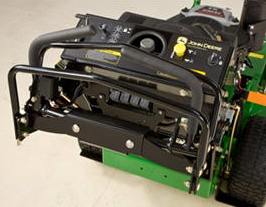 WH Series operator controls
WH Series operator controls

All of the controls on a WH Series Mower are within comfortable reach of the operator.
The location and simplified operation of the following controls on all models offer greater convenience, improved productivity, and increased safety:
- Operator presence system – The bail must be depressed to operate the unit; the machine must be in neutral and the power take-off (PTO) must be disengaged to start.
- Separate choke and throttle – This takes the guesswork out of choke operation, and there is less fouling of plugs.
- Loop-type controls – These controls provide ease of operation.
- Front adjustable cruise bar – This bar allows setting the maximum mowing speed to match conditions.
- Reverse index bar – This bar makes the machine easy to control in reverse.
- Adjustable height of controls for short and tall operators – There are three height settings with 3 in. (7.6 cm) of total adjustment.
- Color-coded and clearly marked switches and buttons – These enable simplified operation.
- Bilingual decals – Decals are provided in English and Spanish.
Self-propelled drive system provides infinite ground-speed adjustments to meet mowing needs
 WH Series drive system
WH Series drive system

The WH Series Mowers are equipped with an infinitely variable hydrostatic drive system with reverse, which does the following:
- Provides infinite ground-speed adjustments - 0 mph to 7 mph (0 km/h to 11.3 km/h) to meet the mowing application
- Enables a smoother transition from one speed to another
- Gives a reverse speed of 3 mph (4.8 km/h), enabling the operator to back out of tight mowing areas and increase productivity
The WH Series Mowers also come equipped with a six-position hydrostatic-transmission adjustment plate. This feature allows an operator to adjust the sensitivity of the hydrostatic transmission to provide ultimate control and comfort.
A 7-gauge, 0.179-in. (4.6-mm), fabricated floating mower deck delivers high-quality cut
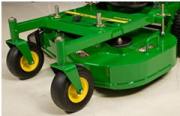 WH36A Mower Deck
WH36A Mower Deck
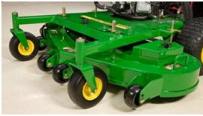 WH48A Mower Deck
WH48A Mower Deck
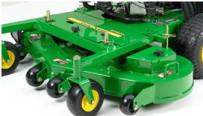 WH52A Mower Deck
WH52A Mower Deck
 WH61A Mower Deck
WH61A Mower Deck
John Deere commercial mower decks have always demonstrated quality, performance, and durability. The 7-gauge, 0.179-in. (4.6-mm), fabricated floating mower deck delivers an extremely high-quality cut in diverse conditions.
Features:
- High blade-tip speed of 18,000 fpm (5,486 m/min) for more blade strikes per inch mowed
- Floating suspension to enable the best-possible cut
- Wide, raised discharge chute for more even clipping distribution
- Reinforced front lower edge for strength and durability
- Easy height-of-cut changes without tools
- Four, dual-captured, adjustable-height anti-scalp wheels
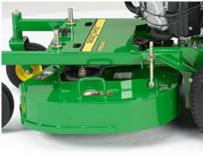 WH36A Mower Deck (side view)
WH36A Mower Deck (side view)
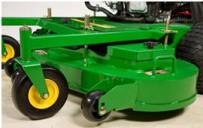 WH48A Mower Deck (side view)
WH48A Mower Deck (side view)
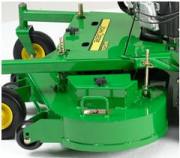 WH52A Mower Deck (side view)
WH52A Mower Deck (side view)
- Tube design with hanger brackets that provide a free-floating deck for a smooth cut with a reduced chance of scalping or scuffing by following the contour of the ground
- Easy-attach belt shields to allow quick access for service
- Wide, rolled lips for additional structural strength
- Greaseable spindles with easy top access for simplified servicing
- Two-coat paint covering to protect and resist corrosion
- Hardened steel blades that extend cutting time and increase durability
- Large discharge to evenly disperse expelled clippings
Flat-free front caster wheels eliminate downtime
 Front caster wheel
Front caster wheel
Rubber, wide-profile, flat-free front caster wheels provide a smooth cut.
Drive wheels provide excellent traction
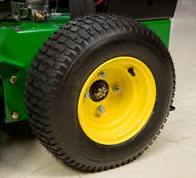 Mower drive wheel on WH36A
Mower drive wheel on WH36A
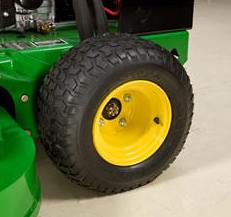 Mower drive wheel on WH48A and WH52A
Mower drive wheel on WH48A and WH52A
Wide and large drive wheels provide excellent traction with low turf compaction. They also provide maximum curb climbing. The square shoulder improves hillside performance.
The tire sizes for the WH Series models are as follows:
- WH36A - 16x6.50-8 in. 4 PR
- WH48A and WH52A - 16x7.50-8 in. 4 PR
- WH61A - 16x8.50-8 in. 4 PR
Exclusive two-year bumper-to-bumper warranty
An exclusive, two-year, single-source, bumper-to-bumper warranty is for all John Deere commercial mowing equipment. The warranty is best in class and places John Deere at the forefront of commercial mowing. It is hassle free, with one company handling all of the paperwork.
- Overhead valve design
- More horsepower and torque per cubic inch of displacement
- Better fuel efficiency
- Less oil consumption
- Cooler operating temperature
- Full-pressure lubrication with full-flow filter
- Reduces engine wear by ensuring proper lubrication, even when operating on hillsides or uneven terrain
- Helps keep oil clean for increased engine life
- V-twin design
- Air-cooled engine design
- Vertical shaft
- Dual-stage air cleaner for extended engine life and efficient operation
- Cylinder head clean-out ports to ease maintenance
- Electric start
- Fuel pump
- Complies with strict U.S. Environmental Protection Agency (EPA) and California Air Resources Board (CARB) emission standards without loss of horsepower or torque
- Consistently strong torque at low- or high-speed operation
- Aluminum block engines
- Effectively dissipate heat
- Lightweight and strong construction
- Extend engine life due to elimination of debilitating engine temperatures
Features
Exclusive two-year bumper-to-bumper warranty
An exclusive, two-year, single-source, bumper-to-bumper warranty is for all John Deere commercial mowing equipment. The warranty is best in class and places John Deere at the forefront of commercial mowing. It is hassle free, with one company handling all of the paperwork.
Flat-free front caster wheels eliminate downtime
 Front caster wheel
Front caster wheel
Rubber, wide-profile, flat-free front caster wheels provide a smooth cut.
Field-installed propane conversion kits for Commercial Walk-Behind Mowers, QuikTrak™ Mowers, and Commercial ZTrak™ Mowers
 Propane conversion kit on a Walk-Behind Mower
Propane conversion kit on a Walk-Behind Mower
 Propane conversion kit on a ZTrak Mower
Propane conversion kit on a ZTrak Mower
John Deere provides application-specific Environmental Protection Agency (EPA) and California Air Resources Board (CARB) approved field-installed propane conversion kits for specific John Deere Commercial Walk-Behind Mowers, QuikTrak Mowers, and ZTrak Mowers. The conversion kits include all components required to convert the engines to operate on propane fuel. Single-tank or dual-tank brackets (depending on the vehicle) are provided for securely holding the propane tank(s) to the vehicle.
Propane tanks are not included.
Optional altitude kit is required when operating at altitudes above 2000 ft (610 m). The operator’s manual provided with the propane conversion kit provides further details. Parts must be ordered separately through John Deere Parts.
Propane facts:
- Propane is flammable and commonly used as a fuel.
- The molecular formula of propane is C3H8, and it is in the family of liquefied petroleum gases (LP gases). The other LP gases include butane, propylene, butadiene, butylene, isobutylene, and mixtures thereof.
- Propane is commonly available and has proven to be a dependable, safe, economical, and clean-burning fuel. It can be used as household fuel, industrial fuel, and fuel for internal combustion engines. Propane has been used as a fuel since 1910.
- At atmospheric pressure, propane boils at -44°F (-42.2°C), meaning it typically exists as a vapor. However, when contained under pressure, such as in a propane cylinder, it can exist as a liquid.
- Propane is naturally odorless, but includes an additive odorant, usually mercaptan, which gives it a distinct odor.
- Vapor propane is heavier than air, meaning it will settle in low areas such as along the ground or in drains.
Advantages of John Deere propane conversion kits include:
- Reduced fuel costs, up to 30 percent depending on fuel prices
- Lower emissions
- Reduced fuel-system maintenance
- Maintains John Deere warranty
- EPA and CARB certified
- May qualify for national and state rebate and incentive programs. Please visit www.propane.com/commercial-landscape/programs-and-incentives/ for further information.
Propane tank mounting bracket options:
 Single propane tank shown on QuikTrak Mower
Single propane tank shown on QuikTrak Mower
 Dual propane tank shown on ZTrak Mower
Dual propane tank shown on ZTrak Mower
Optional tank and configurations and sizes are available to provide operators the ability to tailor for run time:
- Commercial Walk-Behind Mowers have only a single-tank mounting option.
- Single-tank bracket designed for one 20-lb (9.1-kg) or 33-lb (15-kg) Worthington tank.
- Tank is not included.
- Single-tank bracket designed for one 20-lb (9.1-kg) or 33-lb (15-kg) Worthington tank.
- QuikTrak Mowers have single-tank and dual-tank mounting options.
- Single-tank right-side bracket designed for one 33-lb (15-kg) Worthington tank.
- Tank is not included.
- Dual-tank brackets designed for two 20-lb (9.1-kg) Worthington tanks.
- Tanks are not included.
- Single-tank right-side bracket designed for one 33-lb (15-kg) Worthington tank.
- ZTrak Mowers have single-tank and dual-tank mounting options.
- Single-tank left-side bracket designed for one 33-lb (15-kg) or 43-lb (19.5-kg) Worthington tank.
- Tank is not included.
- Dual-tank brackets designed for two 33-lb (15-kg) Worthington tanks.
- Tanks are not included.
- ZTrak Mowers with dual-tank configurations are not compatible with any material collections system.
NOTE: Reference the “Propane and Attachment Compatibility Chart” to determine tank configurations that are compatible.
Estimated run time comparison
| Engine displacement | FS603cc | FS726cc | FX726cc | FX852cc |
| Average consumption (lb [kg]/hr) | 3.9 (1.8) | 4.2 (1.9) | 4.2 (1.9) | 5.8 (2.6) |
| Run time (hours) with 20-lb (9.1-kg) tank | 5.1 | 4.8 | 4.8 | 3.4 |
| Run time (hours) with 33.5-lb (15.2-kg) tank | Not available | 8.0 | 8.0 | 5.8 |
| Run time (hours) with 43.5-lb (19.7-kg) tank | Not available | 10.4 | 10.4 | 7.5 |
Field-installed propane conversion kit compatibility:
NOTE: Conversion to propane is not intended for units with engines having more than 250 hours of use.
Commercial Walk-Behind Mowers
| WG Series | WH Series | WHP Series | |||||||||
| Model | WG32A | WG36A | WG48A | WH36A | WH48A | WH52A | WH61A | WHP36A | WHP48A | WHP52A | WHP61A |
| Engine model | FS481V | FS481V | FS481V | FS481V | FS600V | FS600V | FS691V | FS481V | FS600V | FS600V | FS691V |
| Engine displacement | 603 cc | 603 cc | 603 cc | 603 cc | 603 cc | 603 cc | 726 cc | 603 cc | 603 cc | 603 cc | 726 cc |
| Propane kit model number | Not available | Not available | Not available | FS603cc | FS603cc | FS603cc | FS726cc | FS603cc | FS603cc | FS603cc | FS726cc |
QuikTrak Mowers
| E Series | M Series | R Series | |||||||
| Model | 652E | 636M | 648M | 652M | 648R | 652R | 652R EFI | 661R | 661R EFI |
| Engine model | FX691V | FS600V | FX691V | FX691V | FX691V | FX730V | ECV740 EFI | FX730V | ECV740 EFI |
| Engine displacement | 726 cc | 603 cc | 726 cc | 726 cc | 726 cc | 726 cc | 747 cc | 726 cc | 747 cc |
| Propane kit model number | FX726cc | Not available | Not available | Not available | FX726cc | FX726cc | Not available | FX726cc | Not available |
Commercial ZTrak Mowers
| E Series | M Series | R Series | ||||||||
| Model | Z915E | Z920M | Z925M FF | Z930M | Z930M EFI | Z950M | Z960M | Z930R | Z950R | Z970R |
| Engine model | CV742 | FX730V | FCV740 | FX801V | ECV749 | FX850V | FX921V | FX801V | FX850V | FX1000V |
| Engine displacement | 747 cc | 726 cc | 747 cc | 852 cc | 747 cc | 852 cc | 999 cc | 852 cc | 852 cc | 999 cc |
| Propane kit model number | Not available | FX726cc* | Not available | FX852cc* | Not available | FX852cc* | Not available | FX852cc* | FX852cc* | Not available |
Worthington tanks are manufactured by Worthington Industries, Inc.
Self-propelled drive system provides infinite ground-speed adjustments to meet mowing needs
 WH Series drive system
WH Series drive system

The WH Series Mowers are equipped with an infinitely variable hydrostatic drive system with reverse, which does the following:
- Provides infinite ground-speed adjustments - 0 mph to 7 mph (0 km/h to 11.3 km/h) to meet the mowing application
- Enables a smoother transition from one speed to another
- Gives a reverse speed of 3 mph (4.8 km/h), enabling the operator to back out of tight mowing areas and increase productivity
The WH Series Mowers also come equipped with a six-position hydrostatic-transmission adjustment plate. This feature allows an operator to adjust the sensitivity of the hydrostatic transmission to provide ultimate control and comfort.
A 7-gauge, 0.179-in. (4.6-mm), fabricated floating mower deck delivers high-quality cut
 WH36A Mower Deck
WH36A Mower Deck
 WH48A Mower Deck
WH48A Mower Deck
 WH52A Mower Deck
WH52A Mower Deck
 WH61A Mower Deck
WH61A Mower Deck
John Deere commercial mower decks have always demonstrated quality, performance, and durability. The 7-gauge, 0.179-in. (4.6-mm), fabricated floating mower deck delivers an extremely high-quality cut in diverse conditions.
Features:
- High blade-tip speed of 18,000 fpm (5,486 m/min) for more blade strikes per inch mowed
- Floating suspension to enable the best-possible cut
- Wide, raised discharge chute for more even clipping distribution
- Reinforced front lower edge for strength and durability
- Easy height-of-cut changes without tools
- Four, dual-captured, adjustable-height anti-scalp wheels
 WH36A Mower Deck (side view)
WH36A Mower Deck (side view)
 WH48A Mower Deck (side view)
WH48A Mower Deck (side view)
 WH52A Mower Deck (side view)
WH52A Mower Deck (side view)
- Tube design with hanger brackets that provide a free-floating deck for a smooth cut with a reduced chance of scalping or scuffing by following the contour of the ground
- Easy-attach belt shields to allow quick access for service
- Wide, rolled lips for additional structural strength
- Greaseable spindles with easy top access for simplified servicing
- Two-coat paint covering to protect and resist corrosion
- Hardened steel blades that extend cutting time and increase durability
- Large discharge to evenly disperse expelled clippings
Drive wheels provide excellent traction
 Mower drive wheel on WH36A
Mower drive wheel on WH36A
 Mower drive wheel on WH48A and WH52A
Mower drive wheel on WH48A and WH52A
Wide and large drive wheels provide excellent traction with low turf compaction. They also provide maximum curb climbing. The square shoulder improves hillside performance.
The tire sizes for the WH Series models are as follows:
- WH36A - 16x6.50-8 in. 4 PR
- WH48A and WH52A - 16x7.50-8 in. 4 PR
- WH61A - 16x8.50-8 in. 4 PR
Convenient operator controls improve productivity
 WH Series operator controls
WH Series operator controls

All of the controls on a WH Series Mower are within comfortable reach of the operator.
The location and simplified operation of the following controls on all models offer greater convenience, improved productivity, and increased safety:
- Operator presence system – The bail must be depressed to operate the unit; the machine must be in neutral and the power take-off (PTO) must be disengaged to start.
- Separate choke and throttle – This takes the guesswork out of choke operation, and there is less fouling of plugs.
- Loop-type controls – These controls provide ease of operation.
- Front adjustable cruise bar – This bar allows setting the maximum mowing speed to match conditions.
- Reverse index bar – This bar makes the machine easy to control in reverse.
- Adjustable height of controls for short and tall operators – There are three height settings with 3 in. (7.6 cm) of total adjustment.
- Color-coded and clearly marked switches and buttons – These enable simplified operation.
- Bilingual decals – Decals are provided in English and Spanish.
Powerful air-cooled engine delivers power and reliability
 Air-cooled engine
Air-cooled engine
 Engines have clean-out ports (SN 070001-)
Engines have clean-out ports (SN 070001-)
WH36A Commercial Walk-Behind Mower is powered by a 14.5-hp (10.8-kW) air-cooled, vertical-shaft engine.
WH48A and WH52A Commercial Walk-Behind Mowers are powered by 18.5-hp (13.8-kW) air-cooled, vertical-shaft engines.
WH61A Commercial Walk-Behind Mower is powered by a 23-hp (17.2-kW) air-cooled, vertical-shaft engine.
Engine features:
- Overhead valve design
- More horsepower and torque per cubic inch of displacement
- Better fuel efficiency
- Less oil consumption
- Cooler operating temperature
- Full-pressure lubrication with full-flow filter
- Reduces engine wear by ensuring proper lubrication, even when operating on hillsides or uneven terrain
- Helps keep oil clean for increased engine life
- V-twin design
- Air-cooled engine design
- Vertical shaft
- Dual-stage air cleaner for extended engine life and efficient operation
- Cylinder head clean-out ports to ease maintenance
- Electric start
- Fuel pump
- Complies with strict U.S. Environmental Protection Agency (EPA) and California Air Resources Board (CARB) emission standards without loss of horsepower or torque
- Consistently strong torque at low- or high-speed operation
- Aluminum block engines
- Effectively dissipate heat
- Lightweight and strong construction
- Extend engine life due to elimination of debilitating engine temperatures
Optional grass-collecting system makes collecting thatch and leaves easy
 Grass catcher
Grass catcher
A 3-cu ft (85-L) capacity grass catcher is available as an attachment for field conversion. Made of strong yet lightweight steel, the grass catcher provides an easy means for collecting thatch and leaves.
The grass-collecting system offers the following features:
- Catcher is designed with a large, 3-cu ft (85-L) capacity
- Bottom of the catcher is sloped at an angle for clearing hilly areas and ground obstacles
- Catcher is designed for quick and easy removal and installation
- Handles are large for sturdy gripping while removing and installing the bagger
Features
Powerful air-cooled engine delivers power and reliability
 Air-cooled engine
Air-cooled engine
 Engines have clean-out ports (SN 070001-)
Engines have clean-out ports (SN 070001-)
WH36A Commercial Walk-Behind Mower is powered by a 14.5-hp (10.8-kW) air-cooled, vertical-shaft engine.
WH48A and WH52A Commercial Walk-Behind Mowers are powered by 18.5-hp (13.8-kW) air-cooled, vertical-shaft engines.
WH61A Commercial Walk-Behind Mower is powered by a 23-hp (17.2-kW) air-cooled, vertical-shaft engine.
Engine features:
- Overhead valve design
- More horsepower and torque per cubic inch of displacement
- Better fuel efficiency
- Less oil consumption
- Cooler operating temperature
- Full-pressure lubrication with full-flow filter
- Reduces engine wear by ensuring proper lubrication, even when operating on hillsides or uneven terrain
- Helps keep oil clean for increased engine life
- V-twin design
- Air-cooled engine design
- Vertical shaft
- Dual-stage air cleaner for extended engine life and efficient operation
- Cylinder head clean-out ports to ease maintenance
- Electric start
- Fuel pump
- Complies with strict U.S. Environmental Protection Agency (EPA) and California Air Resources Board (CARB) emission standards without loss of horsepower or torque
- Consistently strong torque at low- or high-speed operation
- Aluminum block engines
- Effectively dissipate heat
- Lightweight and strong construction
- Extend engine life due to elimination of debilitating engine temperatures
Field-installed propane conversion kits for Commercial Walk-Behind Mowers, QuikTrak™ Mowers, and Commercial ZTrak™ Mowers
 Propane conversion kit on a Walk-Behind Mower
Propane conversion kit on a Walk-Behind Mower
 Propane conversion kit on a ZTrak Mower
Propane conversion kit on a ZTrak Mower
John Deere provides application-specific Environmental Protection Agency (EPA) and California Air Resources Board (CARB) approved field-installed propane conversion kits for specific John Deere Commercial Walk-Behind Mowers, QuikTrak Mowers, and ZTrak Mowers. The conversion kits include all components required to convert the engines to operate on propane fuel. Single-tank or dual-tank brackets (depending on the vehicle) are provided for securely holding the propane tank(s) to the vehicle.
Propane tanks are not included.
An optional altitude kit is required when operating at altitudes above 2000 ft (610 m). The operator’s manual provided with the propane conversion kit provides further details. Parts must be ordered separately through John Deere Parts.
Propane facts:
- Propane is flammable and commonly used as a fuel.
- The molecular formula of propane is C3H8, and it is in the family of liquefied petroleum gases (LP gases). The other LP gases include butane, propylene, butadiene, butylene, isobutylene, and mixtures thereof.
- Propane is commonly available and has proven to be a dependable, safe, economical, and clean-burning fuel. It can be used as household fuel, industrial fuel, and fuel for internal combustion engines. Propane has been used as a fuel since 1910.
- At atmospheric pressure, propane boils at -44°F (-42.2°C), meaning it typically exists as a vapor. However, when contained under pressure, such as in a propane cylinder, it can exist as a liquid.
- Propane is naturally odorless, but includes an additive odorant, usually mercaptan, which gives it a distinct odor.
- Vapor propane is heavier than air, meaning it will settle in low areas such as along the ground or in drains.
Advantages of John Deere propane conversion kits include:
- Reduced fuel costs, up to 30 percent depending on fuel prices
- Lower emissions
- Reduced fuel-system maintenance
- Maintains John Deere warranty
- EPA and CARB certified
- May qualify for national and state rebate and incentive programs. Please visit www.propane.com/commercial-landscape/programs-and-incentives/ for further information.
Propane tank mounting bracket options:
 Single propane tank shown on QuikTrak Mower
Single propane tank shown on QuikTrak Mower
 Dual propane tanks shown on ZTrak Mower
Dual propane tanks shown on ZTrak Mower
Optional tank configurations and sizes are available to provide operators the ability to tailor for run time:
- Commercial Walk-Behind Mowers have only a single-tank mounting option.
- The single-tank bracket is designed for one 20-lb (9.1-kg) or 33-lb (15-kg) Worthington tank.
- Tank is not included.
- The single-tank bracket is designed for one 20-lb (9.1-kg) or 33-lb (15-kg) Worthington tank.
- QuikTrak Mowers have single-tank and dual-tank mounting options.
- The single-tank, right-side bracket is designed for one 33-lb (15-kg) Worthington tank.
- Tank is not included.
- The dual-tank brackets are designed for two 20-lb (9.1-kg) Worthington tanks.
- Tanks are not included.
- The single-tank, right-side bracket is designed for one 33-lb (15-kg) Worthington tank.
- ZTrak Mowers have single-tank and dual-tank mounting options.
- The single-tank, left-side bracket is designed for one 33-lb (15-kg) or 43-lb (19.5-kg) Worthington tank.
- Tank is not included.
- The dual-tank brackets are designed for two 33-lb (15-kg) Worthington tanks.
- Tanks are not included.
- ZTrak Mowers with dual-tank configurations are not compatible with any material collection systems.
NOTE: Reference the Propane and Attachment Compatibility Chart to determine tank configurations that are compatible.
Field-installed propane conversion kit compatibility:
NOTE: Conversion to propane is not intended for units with engines having more than 250 hours of use.
Commercial Walk-Behind Mowers
| WG Series | WH Series | WHP Series | |||||||||
| Model | WG32A | WG36A | WG48A | WH36A | WH48A | WH52A | WH61A | WHP36A | WHP48A | WHP52A | WHP61A |
| Engine model | FS481V | FS481V | FS481V | FS481V | FS600V | FS600V | FS691V | FS481V | FS600V | FS600V | FS691V |
| Engine displacement | 603 cc | 603 cc | 603 cc | 603 cc | 603 cc | 603 cc | 726 cc | 603 cc | 603 cc | 603 cc | 726 cc |
| Propane kit model number | Not available | Not available | Not available | FS603cc | FS603cc | FS603cc | FS726cc | FS603cc | FS603cc | FS603cc | FS726cc |
QuikTrak Mowers
| E Series | M Series | R Series | |||||||
| Model | 652E | 636M | 648M | 652M | 648R | 652R | 652R EFI | 661R | 661R EFI |
| Engine model | FX691V | FS600V | FX691V | FX691V | FX691V | FX730V | ECV740 EFI | FX730V | ECV740 EFI |
| Engine displacement | 726 cc | 603 cc | 726 cc | 726 cc | 726 cc | 726 cc | 747 cc | 726 cc | 747 cc |
| Propane kit model number | FX726cc | Not available | Not available | Not available | FX726cc | FX726cc | Not available | FX726cc | Not available |
Commercial ZTrak Mowers
| E Series | M Series | R Series | |||||||||
| Model | Z915E | Z920M | Z925M FF | Z930M | Z945M EFI | Z950M | Z955M EFI | Z960M | Z930R | Z950R | Z970R |
| Engine model | CV742 | FX730V | FCV740 | FX801V | ECV850 EFI | FX850V | ECV860J EFI | FX921V | FX801V | FX850V | FX1000V |
| Engine displacement | 747 cc | 726 cc | 747 cc | 852 cc | 824 cc | 852 cc | 824 cc | 999 cc | 852 cc | 852 cc | 999 cc |
| Propane kit model number | Not available | FX726cc* | Not available | FX852cc* | Not available | FX852cc* | Not available | Not available | FX852cc* | FX852cc* | Not available |
Worthington tanks are manufactured by Worthington Industries, Inc.
Estimated run-time comparison
| Engine displacement | FS603cc | FS726cc | FX726cc | FX852cc |
| Average consumption (lb [kg]/hr) | 3.9 (1.8) | 4.2 (1.9) | 4.2 (1.9) | 5.8 (2.6) |
| Run time (hours) with 20-lb (9.1-kg) tank | 5.1 | 4.8 | 4.8 | 3.4 |
| Run time (hours) with 33.5-lb (15.2-kg) tank | Not available | 8.0 | 8.0 | 5.8 |
| Run time (hours) with 43.5-lb (19.7-kg) tank | Not available | 10.4 | 10.4 | 7.5 |
Convenient operator controls improve productivity
 WH Series operator controls
WH Series operator controls

All of the controls on a WH Series Mower are within comfortable reach of the operator.
The location and simplified operation of the following controls on all models offer greater convenience, improved productivity, and increased safety:
- Operator presence system – The bail must be depressed to operate the unit; the machine must be in neutral and the power take-off (PTO) must be disengaged to start.
- Separate choke and throttle – This takes the guesswork out of choke operation, and there is less fouling of plugs.
- Loop-type controls – These controls provide ease of operation.
- Front adjustable cruise bar – This bar allows setting the maximum mowing speed to match conditions.
- Reverse index bar – This bar makes the machine easy to control in reverse.
- Adjustable height of controls for short and tall operators – There are three height settings with 3 in. (7.6 cm) of total adjustment.
- Color-coded and clearly marked switches and buttons – These enable simplified operation.
- Bilingual decals – Decals are provided in English and Spanish.
Self-propelled drive system provides infinite ground-speed adjustments to meet mowing needs
 WH Series drive system
WH Series drive system

The WH Series Mowers are equipped with an infinitely variable hydrostatic drive system with reverse, which does the following:
- Provides infinite ground-speed adjustments - 0 mph to 7 mph (0 km/h to 11.3 km/h) to meet the mowing application
- Enables a smoother transition from one speed to another
- Gives a reverse speed of 3 mph (4.8 km/h), enabling the operator to back out of tight mowing areas and increase productivity
The WH Series Mowers also come equipped with a six-position hydrostatic-transmission adjustment plate. This feature allows an operator to adjust the sensitivity of the hydrostatic transmission to provide ultimate control and comfort.
A 7-gauge, 0.179-in. (4.6-mm), fabricated floating mower deck delivers high-quality cut
 WH36A Mower Deck
WH36A Mower Deck
 WH48A Mower Deck
WH48A Mower Deck
 WH52A Mower Deck
WH52A Mower Deck
 WH61A Mower Deck
WH61A Mower Deck
John Deere commercial mower decks have always demonstrated quality, performance, and durability. The 7-gauge, 0.179-in. (4.6-mm), fabricated floating mower deck delivers an extremely high-quality cut in diverse conditions.
Features:
- High blade-tip speed of 18,000 fpm (5,486 m/min) for more blade strikes per inch mowed
- Floating suspension to enable the best-possible cut
- Wide, raised discharge chute for more even clipping distribution
- Reinforced front lower edge for strength and durability
- Easy height-of-cut changes without tools
- Four, dual-captured, adjustable-height anti-scalp wheels
 WH36A Mower Deck (side view)
WH36A Mower Deck (side view)
 WH48A Mower Deck (side view)
WH48A Mower Deck (side view)
 WH52A Mower Deck (side view)
WH52A Mower Deck (side view)
- Tube design with hanger brackets that provide a free-floating deck for a smooth cut with a reduced chance of scalping or scuffing by following the contour of the ground
- Easy-attach belt shields to allow quick access for service
- Wide, rolled lips for additional structural strength
- Greaseable spindles with easy top access for simplified servicing
- Two-coat paint covering to protect and resist corrosion
- Hardened steel blades that extend cutting time and increase durability
- Large discharge to evenly disperse expelled clippings
Flat-free front caster wheels eliminate downtime
 Front caster wheel
Front caster wheel
Rubber, wide-profile, flat-free front caster wheels provide a smooth cut.
Drive wheels provide excellent traction
 Mower drive wheel on WH36A
Mower drive wheel on WH36A
 Mower drive wheel on WH48A and WH52A
Mower drive wheel on WH48A and WH52A
Wide and large drive wheels provide excellent traction with low turf compaction. They also provide maximum curb climbing. The square shoulder improves hillside performance.
The tire sizes for the WH Series models are as follows:
- WH36A - 16x6.50-8 in. 4 PR
- WH48A and WH52A - 16x7.50-8 in. 4 PR
- WH61A - 16x8.50-8 in. 4 PR
Optional grass-collecting system makes collecting thatch and leaves easy
 Grass catcher
Grass catcher
A 3-cu ft (85-L) capacity grass catcher is available as an attachment for field conversion. Made of strong yet lightweight steel, the grass catcher provides an easy means for collecting thatch and leaves.
The grass-collecting system offers the following features:
- Catcher is designed with a large, 3-cu ft (85-L) capacity
- Bottom of the catcher is sloped at an angle for clearing hilly areas and ground obstacles
- Catcher is designed for quick and easy removal and installation
- Handles are large for sturdy gripping while removing and installing the bagger
Exclusive two-year bumper-to-bumper warranty
An exclusive, two-year, single-source, bumper-to-bumper warranty is for all John Deere commercial mowing equipment. The warranty is best in class and places John Deere at the forefront of commercial mowing. It is hassle free, with one company handling all of the paperwork.
Features
Powerful air-cooled engine delivers power and reliability
 Air-cooled engine
Air-cooled engine
 Engines have clean-out ports (SN 070001-)
Engines have clean-out ports (SN 070001-)
WG Series Commercial Walk-Behind Mowers are powered by 14.5-hp (10.8-kW) air-cooled, vertical-shaft engines.
Engine features:
- Overhead valve design
- More horsepower and torque per cubic inch (cubic meter) of displacement
- Better fuel efficiency
- Less oil consumption
- Cooler operating temperature
- Full-pressure lubrication with full-flow filter
- Reduces engine wear by ensuring proper lubrication, even when operating on hillsides or uneven terrain
- Helps keep oil clean for increased engine life
- V-twin design
- Air-cooled engine design
- Vertical shaft
- Dual-stage air cleaner for extended engine life and efficient operation
- Cylinder head clean-out ports to ease maintenance
- Recoil start
- Fuel pump
- Complies with strict U.S. Environmental Protection Agency (EPA) and California Air Resources Board (CARB) emission standards without loss of horsepower or torque
- Consistently strong torque at low- or high-speed operation
- Aluminum block engines
- Effectively dissipate heat
- Are of lightweight and strong construction
- Extend engine life due to elimination of debilitating engine temperatures
Pistol-grip controls within comfortable reach
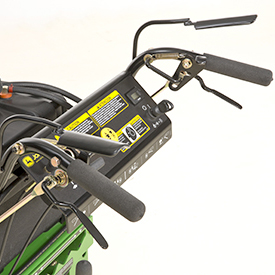 WG Series operator controls (WG32A shown)
WG Series operator controls (WG32A shown)

All of the controls on a WG Series Mower are within comfortable reach of the operator.
The location and operation of the following controls on all models offer greater convenience, improved productivity, and increased safety:
- Operator presence system – the bails must be depressed to operate the unit; the machine must be in neutral and the power take-off (PTO) must be disengaged to start.
- Separate choke and throttle – this takes the guesswork out of choke operation and there is less fouling of plugs.
- Pistol-grip controls – these controls are familiar to most operators and offer simplicity and reliability.
- Color-coded and clearly marked switches and buttons – these simplify operation.
- Bilingual decals – decals are provided in English and Spanish.
Five-speed gearbox for operating flexibility
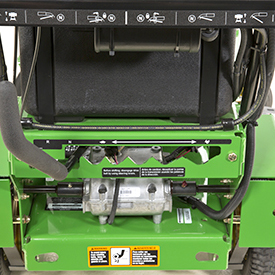 WG Series drive system (WG32A shown)
WG Series drive system (WG32A shown)

The WG Series Mowers are equipped with a 5-speed, gear-drive system with reverse, which does the following:
- Provides superior ground-speed adjustments to meet mowing application needs
- Allows easy, smooth shifting with a padded lever
- Can be shifted on the go
7-gauge, 0.179-in. (4.6-mm), floating mower deck delivers high-quality cut
 WG32 Mower Deck
WG32 Mower Deck
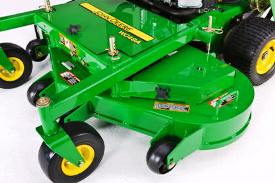 WG Series Mower Deck (WG48A shown)
WG Series Mower Deck (WG48A shown)
John Deere commercial mower decks have always demonstrated quality, performance, and durability. The 7-gauge, 0.179-in. (4.6-mm), floating fabricated deck for WG Series Mowers delivers an extremely high-quality cut in diverse conditions.
Features:
- High blade-tip speed of 18,000 fpm (5,486 m/min) for more blade strikes per inch (millimeter) mowed
- Fully-floating, fabricated deck provides maximum contour following
- Wide, raised discharge chute for more even clipping distribution
- Reinforced front lower edge for strength and durability
- Easy height-of-cut changes
- Easy-attach belt shields to allow quick access for service
- Wide, reinforced lips for additional structural strength
- Greaseable spindles with easy access for simplified servicing
- Two-coat paint covering to protect and resist corrosion
- Hardened steel blades that extend cutting time and increase durability
- Large discharge to evenly disperse expelled clippings
Flat-free front caster wheels eliminate downtime
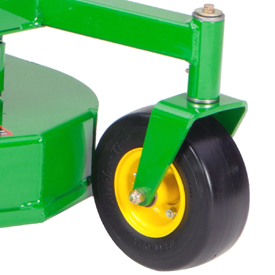 WG Series front caster wheel
WG Series front caster wheel

Rubber, wide-profile, flat-free front caster wheels provide a smooth cut.
Exclusive two-year bumper-to-bumper warranty
An exclusive, two-year, single-source, bumper-to-bumper warranty is for all John Deere commercial mowing equipment. The warranty is best in class and places John Deere at the forefront of commercial mowing. It is hassle free, with one company handling all of the paperwork.
Features
Powerful air-cooled engine delivers power and reliability
 Air-cooled engine
Air-cooled engine
 Engines have clean-out ports (SN 070001-)
Engines have clean-out ports (SN 070001-)
WG Series Commercial Walk-Behind Mowers are powered by 14.5-hp (10.8-kW) air-cooled, vertical-shaft engines.
Engine features:
- Overhead valve design
- More horsepower and torque per cubic inch (cubic meter) of displacement
- Better fuel efficiency
- Less oil consumption
- Cooler operating temperature
- Full-pressure lubrication with full-flow filter
- Reduces engine wear by ensuring proper lubrication, even when operating on hillsides or uneven terrain
- Helps keep oil clean for increased engine life
- V-twin design
- Air-cooled engine design
- Vertical shaft
- Dual-stage air cleaner for extended engine life and efficient operation
- Cylinder head clean-out ports to ease maintenance
- Recoil start
- Fuel pump
- Complies with strict U.S. Environmental Protection Agency (EPA) and California Air Resources Board (CARB) emission standards without loss of horsepower or torque
- Consistently strong torque at low- or high-speed operation
- Aluminum block engines
- Effectively dissipate heat
- Are of lightweight and strong construction
- Extend engine life due to elimination of debilitating engine temperatures
Pistol-grip controls within comfortable reach
 WG Series operator controls (WG32A shown)
WG Series operator controls (WG32A shown)

All of the controls on a WG Series Mower are within comfortable reach of the operator.
The location and operation of the following controls on all models offer greater convenience, improved productivity, and increased safety:
- Operator presence system – the bails must be depressed to operate the unit; the machine must be in neutral and the power take-off (PTO) must be disengaged to start.
- Separate choke and throttle – this takes the guesswork out of choke operation and there is less fouling of plugs.
- Pistol-grip controls – these controls are familiar to most operators and offer simplicity and reliability.
- Color-coded and clearly marked switches and buttons – these simplify operation.
- Bilingual decals – decals are provided in English and Spanish.
Five-speed gearbox for operating flexibility
 WG Series drive system (WG32A shown)
WG Series drive system (WG32A shown)

The WG Series Mowers are equipped with a 5-speed, gear-drive system with reverse, which does the following:
- Provides superior ground-speed adjustments to meet mowing application needs
- Allows easy, smooth shifting with a padded lever
- Can be shifted on the go
7-gauge, 0.179-in. (4.6-mm), floating mower deck delivers high-quality cut
 WG32 Mower Deck
WG32 Mower Deck
 WG Series Mower Deck (WG48A shown)
WG Series Mower Deck (WG48A shown)
John Deere commercial mower decks have always demonstrated quality, performance, and durability. The 7-gauge, 0.179-in. (4.6-mm), floating fabricated deck for WG Series Mowers delivers an extremely high-quality cut in diverse conditions.
Features:
- High blade-tip speed of 18,000 fpm (5,486 m/min) for more blade strikes per inch (millimeter) mowed
- Fully-floating, fabricated deck provides maximum contour following
- Wide, raised discharge chute for more even clipping distribution
- Reinforced front lower edge for strength and durability
- Easy height-of-cut changes
- Easy-attach belt shields to allow quick access for service
- Wide, reinforced lips for additional structural strength
- Greaseable spindles with easy access for simplified servicing
- Two-coat paint covering to protect and resist corrosion
- Hardened steel blades that extend cutting time and increase durability
- Large discharge to evenly disperse expelled clippings
Flat-free front caster wheels eliminate downtime
 WG Series front caster wheel
WG Series front caster wheel

Rubber, wide-profile, flat-free front caster wheels provide a smooth cut.
Exclusive two-year bumper-to-bumper warranty
An exclusive, two-year, single-source, bumper-to-bumper warranty is for all John Deere commercial mowing equipment. The warranty is best in class and places John Deere at the forefront of commercial mowing. It is hassle free, with one company handling all of the paperwork.
Features
Powerful air-cooled engine delivers power and reliability
 Air-cooled engine
Air-cooled engine
 Engines have clean-out ports (SN 070001-)
Engines have clean-out ports (SN 070001-)
WG Series Commercial Walk-Behind Mowers are powered by 14.5-hp (10.8-kW) air-cooled, vertical-shaft engines.
Engine features:
- Overhead valve design
- More horsepower and torque per cubic inch (cubic meter) of displacement
- Better fuel efficiency
- Less oil consumption
- Cooler operating temperature
- Full-pressure lubrication with full-flow filter
- Reduces engine wear by ensuring proper lubrication, even when operating on hillsides or uneven terrain
- Helps keep oil clean for increased engine life
- V-twin design
- Air-cooled engine design
- Vertical shaft
- Dual-stage air cleaner for extended engine life and efficient operation
- Cylinder head clean-out ports to ease maintenance
- Recoil start
- Fuel pump
- Complies with strict U.S. Environmental Protection Agency (EPA) and California Air Resources Board (CARB) emission standards without loss of horsepower or torque
- Consistently strong torque at low- or high-speed operation
- Aluminum block engines
- Effectively dissipate heat
- Are of lightweight and strong construction
- Extend engine life due to elimination of debilitating engine temperatures
Pistol-grip controls within comfortable reach
 WG Series operator controls (WG32A shown)
WG Series operator controls (WG32A shown)

All of the controls on a WG Series Mower are within comfortable reach of the operator.
The location and operation of the following controls on all models offer greater convenience, improved productivity, and increased safety:
- Operator presence system – the bails must be depressed to operate the unit; the machine must be in neutral and the power take-off (PTO) must be disengaged to start.
- Separate choke and throttle – this takes the guesswork out of choke operation and there is less fouling of plugs.
- Pistol-grip controls – these controls are familiar to most operators and offer simplicity and reliability.
- Color-coded and clearly marked switches and buttons – these simplify operation.
- Bilingual decals – decals are provided in English and Spanish.
Five-speed gearbox for operating flexibility
 WG Series drive system (WG32A shown)
WG Series drive system (WG32A shown)

The WG Series Mowers are equipped with a 5-speed, gear-drive system with reverse, which does the following:
- Provides superior ground-speed adjustments to meet mowing application needs
- Allows easy, smooth shifting with a padded lever
- Can be shifted on the go
7-gauge, 0.179-in. (4.6-mm), floating mower deck delivers high-quality cut
 WG32 Mower Deck
WG32 Mower Deck
 WG Series Mower Deck (WG48A shown)
WG Series Mower Deck (WG48A shown)
John Deere commercial mower decks have always demonstrated quality, performance, and durability. The 7-gauge, 0.179-in. (4.6-mm), floating fabricated deck for WG Series Mowers delivers an extremely high-quality cut in diverse conditions.
Features:
- High blade-tip speed of 18,000 fpm (5,486 m/min) for more blade strikes per inch (millimeter) mowed
- Fully-floating, fabricated deck provides maximum contour following
- Wide, raised discharge chute for more even clipping distribution
- Reinforced front lower edge for strength and durability
- Easy height-of-cut changes
- Easy-attach belt shields to allow quick access for service
- Wide, reinforced lips for additional structural strength
- Greaseable spindles with easy access for simplified servicing
- Two-coat paint covering to protect and resist corrosion
- Hardened steel blades that extend cutting time and increase durability
- Large discharge to evenly disperse expelled clippings
Flat-free front caster wheels eliminate downtime
 WG Series front caster wheel
WG Series front caster wheel

Rubber, wide-profile, flat-free front caster wheels provide a smooth cut.
Exclusive two-year bumper-to-bumper warranty
An exclusive, two-year, single-source, bumper-to-bumper warranty is for all John Deere commercial mowing equipment. The warranty is best in class and places John Deere at the forefront of commercial mowing. It is hassle free, with one company handling all of the paperwork.
Features
Engine is 3-cylinder diesel for fuel economy and durability
 24-hp (17.9-kW) diesel engine
24-hp (17.9-kW) diesel engine
 Diesel engine
Diesel engine
A liquid-cooled, 3-cylinder diesel engine provides exceptional power, performance, fuel economy, and durability to handle commercial-use applications:
- Large displacement provides exceptional torque
- Cast-iron block improves noise absorption
- Quality features include cast-iron cylinder liners, overhead valves, full-pressure lubrication, and replaceable oil filter
- Solenoid-shift starter ensures easy starts, even in cold weather
- High-energy glow plugs ensure quick starts in cold weather; an automatic sensing system tells the operator when the engine is ready to start
- Mechanical fuel bleed eliminates the need for tools and fuel leaking onto the ground when bleeding the fuel system:
- Simply pump the fuel pump that is located on the side of the engine
- Electric fuel shutoff eliminates the need for a separate kill switch
- Indirect injection with pre-combustion chambers provide smooth, quiet operation
- Engine-mounted 40-amp alternator supplies regulated charge to the battery for fast recharge:
- Also provides plenty of power for 12-volt-powered attachments and accessories
- Low exhaust emissions are certified to meet U.S. Environmental Protection Agency (EPA) and state of California standards for cleaner air:
- Overhead valve design for efficient airflow
- Swirl chamber combustion design for efficient combustion
- Liquid cooled for more consistent operating temperatures
- Closed crankcase ventilation recirculates and burns crankcase hydrocarbons
Horsepower (hp) |
Maximum torque |
Cooling |
Displacement |
24 hp (17.9 kW) |
--- |
Liquid |
60.6 cu in. (993 cc) |
Air-intake system
 Air intake screens on hood and pedestal
Air intake screens on hood and pedestal
 Radiator screen pulled out for cleaning
Radiator screen pulled out for cleaning
Engine intake air is drawn in through screened panels at the base of the pedestal and on the right and left sides of the tractor:
- Cleanest and coolest area of the tractor
- Pre-cleans the air to keep large chaff and debris from entering the radiator or air cleaner
- Easy to clean and service so engine operates at optimum temperature
 Diesel engine air cleaner
Diesel engine air cleaner
 Replaceable air filter
Replaceable air filter
The diesel engine uses a heavy-duty cyclonic canister-type replaceable air filter:
- Completely sealed for effective cleaning
- Cyclone action that is designed to eject 90 percent to 95 percent of the dirt before it reaches the paper element
- Secondary safety element that provides additional filtering
- Total effective filter area of 512 sq in. (3303 sq cm)
 Air filter restriction indicator
Air filter restriction indicator
An air filter restriction indicator is standard equipment:
- Indicator light on the dash alerts the operator when the air filter is dirty and needs to be replaced
- With a visual check, air filter daily service is simplified
- Indicator extends the engine life by eliminating inadvertent dirt entry into the engine from over-servicing of the air filter
Fuel tank has a large 5.2-U.S. gal. (19.7-L) capacity
 Fuel cap and tank (shown on X758 Diesel Tractor)
Fuel cap and tank (shown on X758 Diesel Tractor)
 Fuel filter, separator, and shutoff
Fuel filter, separator, and shutoff
A large, 5.2-U.S. gal. (19.7-L) capacity fuel tank holds enough fuel for extended operation between refills:
- Fuel-fill location is on the left fender for easy access, increased safety, fewer spills, and convenience during filling.
- A fuel filter/separator with replaceable element includes a shutoff valve and is conveniently located on the front of the engine.
Battery and alternator are large capacity
 Battery located at front of tractor frame
Battery located at front of tractor frame
A high-capacity, regulated alternator charging system provides plenty of power to quickly recharge the battery and run electrical equipment, such as lights or a sprayer:
- 40-amp alternator is provided as standard equipment on diesel engines.
A large-capacity, 500 cold-cranking amp battery provides plenty of cranking power for quick, sure starts in cold weather:
- Mounted at the front of the tractor frame for easy accessibility
54-in. (137-cm) and 60-in. (152-cm) Edge™ High-Capacity (HC) Mower Decks are heavy duty
 X739 Tractor mowing with 54-in. (137-cm) HC Mower Deck
X739 Tractor mowing with 54-in. (137-cm) HC Mower Deck
 Side view of mower deck
Side view of mower deck
A deep-deck design of 5.5 in. (14 cm) delivers excellent airflow so material can be processed quickly and efficiently. The deck is stamped from 9-gauge, 0.15-in. (3.8-mm) steel and has welded-on reinforcement at the bottom edge for extra strength and durability.
 60-in. (152-cm) HC Mower Deck top view
60-in. (152-cm) HC Mower Deck top view
 54-in. (137-cm) HC Mower Deck bottom view
54-in. (137-cm) HC Mower Deck bottom view
High-capacity mower decks are formed in a hydraulic press to minimize the number of welds and provide a smooth underside for reduced material buildup:
- Wider and higher discharge opening provides an even clipping dispersal for an excellent finished appearance in all conditions.
- Durable plastic deflector spreads grass clippings evenly across the lawn, is hinged, and can be raised to minimize the storage space required.
- 1-in. (2.5-cm) cold-forged spindles are heat-treated for strength and supported by ball bearings.
- Front edge is raised above the blade plane to allow even cutting of tall grass.
- Blade overlap is greater than many conventional decks for a clean cut.
- Mower can side-discharge, mulch (optional), or use a Power Flow™ collection system (optional).
 MulchControl with baffle closed
MulchControl with baffle closed
 MulchControl with baffle open
MulchControl with baffle open
The MulchControl attachment makes mulching more practical for many mowing situations because it not only does an excellent job of mulching but it also allows the mower to be easily converted for times when it is more desirable to side discharge or collect the lawn material. Advantages of mulching grass clippings include:
- A beautiful looking lawn
- Grass clippings not blown onto the operator, driveways, or flower beds
- Less fertilizer use
- Elimination of the effort needed to dispose of clippings
MulchControl is an innovative, simple design that is easy to use and maintain:
- The MulchControl attachment includes baffles to control the flow of material under the deck.
- The left mower blade area is completely enclosed and optimized for mulching, thus will mulch even when the mower is in the side-discharge mode.
- Baffles around the center and right blades are optimized for mulching when the discharge baffle is closed.
MulchControl operation
 MulchControl handle (standard with MulchControl)
MulchControl handle (standard with MulchControl)
 Hydraulic MulchControl actuator option
Hydraulic MulchControl actuator option
The optional MulchControl attachment comes with a handle on top of the mower deck that is used to open and close the discharge baffle:
- The operator is required to get off of the machine in order to engage or disengage mulch mode.
An optional hydraulic MulchControl actuator attachment is available to replace the standard control lever and allow the operator to control MulchControl from the seat using the tractor’s hydraulic control lever.
NOTE: To have hydraulic control of the MulchControl baffle, both MulchControl and hydraulic MulchControl actuator attachments must be ordered. The hydraulic MulchControl actuator is an extra-cost option for the MulchControl attachment.
Changing from mulching to side discharge or vice versa with the hand lever or hydraulic MulchControl actuator option takes only a few seconds.
MulchControl is well-suited to the following mowing situations:
- Usually mulch, but side discharge when grass gets too long
- Usually side discharge, but would like to be able to close the chute to control clippings
- Always mulch a main lawn, but often side discharge secondary lawns
- Bag clippings, but want to go farther before emptying bags
MulchControl puts the operator in control of the clippings. Now the operator can have all the benefits of mulching with the ability to easily change to side-discharge or bagging when needed.
MulchControl limitations
While in the side-discharge mode, MulchControl will still mulch about one-third of the material. Therefore, the side-discharge mode is essentially a partial-mulch mode. This can be an advantage when side discharging or bagging, as it helps to reduce the amount of material being discharged. Other times this could work as a disadvantage:
- When cutting strong southern grasses, such as Zoysia and Bermuda
- When cutting in wet, high-growth conditions, such as those found in the Pacific Northwest United States
- When optimum bagging and lawn clean-up is desired
MulchControl compatibility
MulchControl is a field-installed attachment. Mulching blades are included:
- MulchControl is for 2015 and newer X700 Signature Series Tractor and:
- 9074M 54-in. (137-cm) HC Mower Deck (serial number 030,001-070,000)
- 9078M 54-in. (137-cm) HC Mower Deck (serial number 070,001-)
- 9075M 60-in. (152-cm) HC Mower Deck (serial number 030,001-070,000)
- 9079M 60-in. (152-cm) HC Mower Deck (serial number 070,001-)
- Optional hydraulic MulchControl actuator (BUC10536) is available for model year 2019 and newer mower decks (9078M and 9079M) only. In addition, mower must be equipped with the basic MulchControl attachment.
NOTE: The hydraulic MulchControl actuator is not available for the 48-in. (122-cm) Accel Deep™ Mower Deck.
Order:
BM26300 MulchControl attachment (54 HC)
BM25258 MulchControl attachment (60 HC)
BUC10536 Hydraulic MulchControl actuator
 Tire-grab feature and shark tooth shaped grips
Tire-grab feature and shark tooth shaped grips
 Drive-over ramp removed for spindle access
Drive-over ramp removed for spindle access
Ramps are provided to permit driving over the mower deck for installing and removing it from the tractor:
- Constructed of 30 percent glass-filled polypropylene for strength to carry the weight of the tractor
- Polypropylene material will not rust or corrode for lasting good appearance
- Shark tooth shaped grips designed into the ramp inclines for added wheel traction when driving onto the mower deck
- Tire grab at the rear of the ramp gives extra wheel traction
- Ramps removed and replaced without tools to permit convenient servicing of the mower spindles
 Mower wash port
Mower wash port
 Mower wash port with hose connector
Mower wash port with hose connector
A wash port is provided to make cleaning the underside of the mower deck easy:
- Hose connector is included with the mower deck.
Optional high-performance mulching attachment
 Mulching attachment components (48 HC shown)
Mulching attachment components (48 HC shown)
The high-performance mulching attachment provides excellent mulching performance:
- This is a high-performance mulching attachment that includes formed steel baffles to control the material and special mulching blades for superior performance.
- The special mulching blades that are included can also be used for side discharging and collecting, though overall performance may be slightly less than with the standard blades.
- Order: BM23977, 54 HC mulching attachment or BM23978 60 HC mulching attachment
Optional MulchControl™ attachment
Mower deck attachability
 X758 Tractor driving onto high-capacity mower deck
X758 Tractor driving onto high-capacity mower deck
High-capacity mower decks have ramps positioned on top of the deck for easy installation:
- On a four-wheel drive (4WD) tractor, the operator can simply drive onto and over the deck.
- On a two-wheel drive (2WD) tractor, the operator must back onto and over the deck.
To remove the mower deck:
- Disconnect the drive shaft.
- Unlock the draft arm locks.
- Back or drive the tractor onto and off the mower deck.
- On a 4WD tractor, the operator can simply back onto and off the deck.
- On a 2WD tractor, the operator can simply drive forward onto and off the deck.
Optional AutoConnect™ drive (BM25677)
 X758 Tractor driving onto high-capacity mower deck
X758 Tractor driving onto high-capacity mower deck
 AutoConnect option installed on X758 Tractor
AutoConnect option installed on X758 Tractor
The AutoConnect driveshaft is an optional kit that will automatically connect or remove the drive from the mower deck to the tractor's mid power take-off (PTO) shaft.
The AutoConnect drive does not need to be removed from the tractor when using front-powered equipment.
Drive-over mower quick reference (major steps)
John Deere has designed a system that makes it easy to remove and reinstall the mower deck. A few steps need to be followed carefully to ensure success.
The list below includes the major steps. Refer to the operator’s manual for a more detailed procedure. The tractor most likely has the mower already installed, so these steps begin with the removal procedure.
DRIVEJD - Always Dependable Product
Mower removal steps
Drive tractor to level area.
Ready mower deck.
- Adjust wheels and lower mower deck
- Draft arms removed (front) and released (rear)
- Power take-off (PTO): disconnect if manual PTO-connect system, then back up to clear rear draft arms (If equipped with AutoConnect™, backing up also disconnects the PTO)
- Raise rear draft arms
Increase engine speed, engage traction assist, and drive over.
Mower installation steps
Verify tractor and mower are ready.
- Alignment of tractor and mower deck
- Draft arms up
- PTO in correct position (If manual PTO connect, place shaft in mower hanger)
Engage traction assist, increase engine speed, and drive or back over.
Join mower to tractor.
- Alignment and attachment verified and PTO connected
- Draft arms hookup, front
- Position mower wheels
Done! Set mower deck height and mow.
Four-year or 700-hour bumper-to-bumper warranty is standard
An exclusive 4-year or 700-hour (whichever comes first), single-source, bumper-to-bumper warranty* is standard for all John Deere X700 Series Tractors.
- The warranty is hassle free, with one company handling all of the paperwork.
- Premium features of X700 Series Tractors allow for this longer warranty period, with more coverage than comparable tractors.
*Term limited to years or hours used, whichever comes first, and varies by model. See the LIMITED WARRANTY FOR NEW JOHN DEERE TURF AND UTILITY EQUIPMENT at JohnDeere.com or JohnDeere.ca/TUWarranty for details.
Hydrostatic four-wheel drive (4WD) with Twin Touch™ control gives superior traction and easy operation
 Twin Touch foot control
Twin Touch foot control
 Cruise control
Cruise control
Twin Touch foot pedals control the speed and direction of travel:
- Automotive-type accelerator control for easy operation
- Twin Touch design that allows operator to change direction without lifting foot off platform
- Large pedal surface for increased operator comfort
When the master brake pedal is depressed, the power take-off (PTO) and cruise control disengage.
Cruise control is standard equipment:
- To engage, push in on the cruise lever and hold until the foot is removed from the forward pedal.
- For emergency stop, the cruise control can be released by pushing on the master brake pedal or pushing down on the forward pedal.
Heavy-duty two-wheel steer or four-wheel steer transaxle
 X758 two-wheel steer transaxle shown
X758 two-wheel steer transaxle shown
A rugged, heavy-duty commercial hydrostatic transaxle handles a wide variety of ground-engaging applications and commercial mowing usage. A hitch for tow-behind equipment is included. The tractor frame extends behind the transaxle to provide mounting points for the category 1 3-point hitch and Click-N-Go™ mounting brackets.
Many quality features are provided:
- Universal joint splined drive shaft between the engine and transmission is durable and gives efficient power transfer (no belts, no slippage, no power loss).
- Shaft drive output through continuous live transmission PTO has no belts to slip or wear out.
- Internal hydraulic PTO with multi-disk clutch pack:
- Soft, smooth clutch engagement
- Long disk life with continuous oil bath
- No service required, as disks are self-adjusting
- Internal, wet-disk brakes:
- Isolated from dirt, rust, ice, or other contaminants for effective brake operation
- Constantly cooled by transmission fluid to minimize wear and eliminate loss of brakes from overheating
- Quiet design virtually eliminates hydrostatic whine.
- Large, efficient 8-cc charge pump produces excellent flow and pressure to allow operating a variety of hydraulic powered equipment.
- Externally mounted, oil-filled shock absorber in the transmission control system ensures smooth starts and stops.
- Exceptional strength and durability:
- Automotive-type forged flanged axles
- Cast-iron axle housings
- Uses an axial piston-type hydrostatic pump and motor versus less-efficient ball-type rotating groups
 Two-wheel steer hydrostatic transaxle
Two-wheel steer hydrostatic transaxle
 Four-wheel steer hydrostatic transaxle
Four-wheel steer hydrostatic transaxle
Two-wheel drive (2WD) and 4WD tractors use similar transaxles, however, four-wheel steer tractors have additional features that allow the rear wheels to turn.
 Differential lock control
Differential lock control
Infinite control of ground speed and smooth change of direction provide efficiency and operator convenience. The differential lock provides positive power to both drive wheels for increased traction. It can be engaged by the operator as needed.
| Forward | 0 to 8.5 mph (0 to 13.7 km/h) |
| Reverse | 0 to 6 mph (0 to 9.7 km/h) |
Transmission oil cooler
The transmission oil cooler is standard equipment:
- Helps keep oil temperatures cooler during high draft load operations
- Separate automotive-style cooler that provides increased capacity for the oil cooler as well as the radiator, when compared to an oil cooler internal to the radiator
Full-time 4WD for superior traction
 X738 Tractor mowing
X738 Tractor mowing
 Full-time 4WD front axle
Full-time 4WD front axle
The full-time 4WD front axle provides a superior combination of traction and maneuverability. When the tractor is in a turn, the front wheels need to rotate faster because of the larger arc, compared to the rear wheels, they are traveling in. The hydrostatic front-wheel motors automatically increase the average travel speed of the front wheels when the tractor is in a turn.
The full-time 4WD system optimizes steering performance to provide maneuverability and trimming ability comparable to that of 2WD models, turning radius of 25 in. (63.5 cm) for two-wheel steer models and 21 in. (53.3 cm) for four- wheel steer models, with the added benefit of four-wheel traction.
Full-time 4WD front-wheel motors are powered by the same pressurized hydraulic fluid that powers the rear transaxle drive motor:
- Hydraulic lines move the pressurized fluid from the rear axle to the front-wheel drive motors, located near the center of the front axle, after the oil has passed through the rear transaxle drive motor.
- The two front wheel motors receive fluid in parallel so each gets the amount of fluid needed to enable different speeds during turns, similar to a differential assembly, and allow smooth turns.
- Turning radius of tractors with full-time 4WD is the same as for 2WD models, and considerably less than the turning radius for tractors with mechanical 4WD.
- Full-time 4WD functions in forward and reverse.
 Control arm increases front-wheel speed in turns
Control arm increases front-wheel speed in turns
 Front-wheel drop-axle
Front-wheel drop-axle
- A control rod (looks similar to a steering drag link) adjusts the swash plate of the variable-speed wheel motors, so each wheel motor is operated at the optimum speed during turns to minimize tire scuffing and assist in making tight turns.
- Front-wheel drop-axles provide extra-tight steering capability, improved ground clearance, and include speed-reduction gearing.
Operator station is comfortable and convenient
 X730 Tractor mowing
X730 Tractor mowing
 Tilt steering wheel
Tilt steering wheel
The tilt steering wheel can be adjusted for optimum operator comfort:
- Six positions can be selected with the push of a lever for the most comfortable setting.
- The full-up position makes getting on and off the tractor easy.
- The steering wheel is designed for comfortable, no-slip operation.
Two-piece tilt-back seat
 Seat has convenient tilt-back feature
Seat has convenient tilt-back feature
 Seat tilted forward
Seat tilted forward
Two-piece, 21-in. (53-cm) high-back seat, with John Deere branded embroidery, has a thick seat cushion for lasting comfort, even after a full day of use. The back can be angled to maximize operator comfort by using a convenient lever on the side of the seat.
A four-bar adjustable seat suspension and 7-in. (18-cm) slide-rail fore-aft adjustment are provided to optimize operator comfort.
Optional armrest kit
 Adjustable armrest option
Adjustable armrest option
 Left armrest in raised position
Left armrest in raised position
Optional armrests increase operator support and comfort, thus reducing fatigue and improving productivity, especially when mowing for extended periods of time. Armrests are adjustable to suit the operator. The embroidered logo on the seat back makes this upscale seat look as good as it feels.
Optional air-ride suspension seat
 Optional air-ride suspension seat
Optional air-ride suspension seat
 Seat pressure switch and fore-aft adjustment lever
Seat pressure switch and fore-aft adjustment lever
The optional air-ride seat minimizes vibration the operator feels while using the tractor and provides a very smooth ride. This seat has a full pneumatic suspension that is easy for operators to adjust to suit their individual needs. Wide, shaped ergonomic cushions are comfortable and reduce back strain.
Features include:
- Simple switch on the front of the seat makes adjustment easy
- Back-angle adjustment
- Three-position lumbar adjustment
- Armrest height adjustment
- 7-in. (18-cm) fore-aft adjustment
Key benefits of the seat:
- Provides maximum ride comfort and quality, thus minimizing operator fatigue
- Dampens lower frequency vibration better than mechanical suspensions
NOTE: The air-ride seat is compatible with all X700 Signature Series Tractors, model year 2013 and later (serial number 010,001-). Plug and play wiring harness for use with the air-ride suspension seat has been added to model year 2019 tractors (serial number 70,001-) to reduce seat-installation time. Model year 2013-2018 (serial number 010,001-070,000) requires AM146765 wiring harness. See CCMS solution 115258 for more information.
Foot pads
 Foot pads
Foot pads
Foot pads help isolate the operator's feet from vibration:
- Provide a non-slip surface for safer mounting or dismounting the tractor
- Attractive styling
Handgrips, toolbox, cup holder, and 12-V outlet
 Toolbox and handgrip
Toolbox and handgrip
 Toolbox with cover open and cup holder
Toolbox with cover open and cup holder
The fender handles provide a convenient handhold to use when getting on and off the tractor and when operating on slopes:
- Plastic material is durable and will not rust.
- The cup holder is designed to hold a variety of drink container sizes.
- Toolbox provides a safe and convenient location to store tools and supplies.
- Exact Adjust mower leveling tool and gauge storage features are provided in the tool box.
12-V outlet
 12-V outlet
12-V outlet
 12-V outlet with cover open
12-V outlet with cover open
12-V outlet located for the convenience of connecting a variety of electrical and electronic equipment:
- Outlet switch is located on the dash for starting and stopping an electric spreader or sprayer.
Headlights and taillights provide good visibility
 Two high-quality headlights
Two high-quality headlights
Large, automotive-type headlights and taillights provide unsurpassed nighttime illumination:
- Standard 37-W halogen headlights provide excellent nighttime visibility.
- Large automotive-type taillights enhance the tractor's appearance and safety.
- Headlights, taillights, and rear work lights are easily operated with a single dash-mounted switch.
 Taillights, work lights, and backup lights
Taillights, work lights, and backup lights
Rear lights provide visibility for the tractor operator and others:
- Standard backup lights can be turned on full time to double as rear work lights.
- Backup lights come on automatically when the operator depresses the reverse pedal.
Snow removal and yard care equipment
An advantage of X700 Series Garden Tractors is their ability to use attachments for snow removal and a variety of other yard-care tasks.
The front quick-hitch mounting system allows for a tool-free change between the front blade, rotary broom, and snow blower. Additional attachments available for use with the equipment listed below include:
- Quik-Tatch tractor frame weights to add ballast for traction and stability
NOTE: Ballast is required for some applications. - Tire chains or TerraGrip traction belts for extra traction when using snow-removal equipment
- Weather protection (shown below) for operator protection and comfort
47-in. (119-cm) and 54-in. (137-cm) Quick-Hitch Snow Blowers
 47-in. (119-cm) Snow Blower, optional front light kit shown
47-in. (119-cm) Snow Blower, optional front light kit shown
 54-in. (137-cm) Snow Blower, optional front light kit shown
54-in. (137-cm) Snow Blower, optional front light kit shown
NOTE: One drift knife is standard equipment; the second (shown in images above) is optional.
The 47-in. (119-cm) and 54-in. (137-cm) Snow Blowers have the capacity to handle big snow-removal jobs.
The front quick-hitch mounting system allows for a tool-free change between the front blade, rotary broom, and snow blower.
42-in. (107-cm) and 47-in. (122-cm) Rotary Tillers
 42-in. (107-cm) Hydraulic Rotary Tiller
42-in. (107-cm) Hydraulic Rotary Tiller
 647 Rotary Tiller
647 Rotary Tiller
The 42-in. (107-cm) Hydraulic Tiller is a real time-saver in preparing seedbeds, controlling weeds, and other tillage jobs. Potential customers include homeowners, hospitals, schools, nurseries, estates, lawn and garden centers, etc. The hydraulic tiller is quieter, more powerful, and tills up to 6 in. (15 cm) of depth. This provides flexibility for jobs like sod breaking to conventional garden tilling.
A unique feature of the 42-in. (107-cm) Hydraulic Tiller is its ability to operate with either forward or reverse tine rotation. This provides flexibility for jobs from sod breaking to conventional garden tilling.
- In forward tine rotation, the hydraulic motor is on the right side and the tines turn in the same direction as the tractor tires when the tractor travels forward for tilling most soil conditions, including soil already tilled and soft soil.
- In reverse tine rotation, the hydraulic motor is on the left side and the tines turn in the opposite direction as the tractor tires when the tractor travels forward for tilling hard soils or sod.
The 647 Rotary Tiller is 47-in. (122-cm) wide and ideal for preparing seedbeds, controlling weeds, and other tillage jobs for homeowners, golf courses, hospitals, schools, and estates. It requires a tractor equipped with a Category 1, 3-point hitch and 540-rpm rear power take-off (PTO).
52-in. (132-cm) and 60-in. (152-cm) Rotary Brooms
 52-in. (132-cm) Rotary Broom (shown with optional front light kit)
52-in. (132-cm) Rotary Broom (shown with optional front light kit)
 60-in. (152-cm) Heavy-Duty Rotary Broom
60-in. (152-cm) Heavy-Duty Rotary Broom
The 52-in. (132-cm) and 60-in. (152-cm) Rotary Brooms increase tractor versatility by allowing use for a variety of sweeping jobs. The broom effectively meets the needs of commercial, farm, home, and estate operators with four-season versatility:
Spring
Rotary brooms can be used to dethatch lawns and clean off tennis courts and other areas quickly and effectively.
Summer
Rotary brooms effectively perform a wide variety of sweeping jobs, including cleaning sidewalks, parking lots, driveways, construction job sites, and barns. They can also be used for backfilling trenches.
Fall
Rotary brooms can be used to sweep leaves and windrow pine needles. They sweep artificial turf and clean up spectator areas after sporting events.
Winter
Rotary brooms effectively move up to 2 in. (5 cm) of snow, which may eliminate the need for a snow thrower, depending on the geographic area.
54-in. (137-cm) and 60-in. (152-cm) Quick-Hitch Front Blades
 54-in. (137-cm) Quick-Hitch Front Blade
54-in. (137-cm) Quick-Hitch Front Blade
 60-in. (152-cm) Quick-Hitch Front Blade
60-in. (152-cm) Quick-Hitch Front Blade
The 54-in. (137-cm) and 60-in. (152-cm) Front Blades are excellent for moving snow, gravel, dirt, sand, or other loose material. They can be hydraulically angled up to 27 degrees right or left or used in the straight-ahead position.
Weather enclosure and hard-side cab
 Weather enclosure
Weather enclosure
 Hard-side cab
Hard-side cab
The roomy steel-frame weather enclosure shields the operator against snow, rain, sun, and wind.
This hard-side cab is rollover protection structure (ROPS) certified for extra protection:
- An electric front windshield wiper is included.
- Optional attachments for the hard-side cab include a heater, heater disconnect kit, inside and outside mirrors, rear window wiper, strobe light, work lights, switch panel fuse block kit, and optional tractor alternators to provide extra capacity to operate the cab accessories.
Instruments and controls are easy to find and use
 Instrumentation and controls (switch turned off)
Instrumentation and controls (switch turned off)
 Gauges and indicator lights (switch turned on to illustrate functions)
Gauges and indicator lights (switch turned on to illustrate functions)
The contoured dash has clean, attractive styling and ergonomic controls for easy use:
- Controls are color coded for easy identification by the operator.
- Controls are logically placed and easy to reach.
- The power take-off (PTO) switch allows the operator to get fingers underneath it, like a T-handle, to pull up for easy activation.
- The reverse implement option (RIO) switch is an easy-to-see and easy-to-use yellow button.
- Cruise control activation is handled by an automotive-style button.
- Functional design of the throttle control provides good appearance and a comfortable feel.
 Display panel illustration with descriptions
Display panel illustration with descriptions
The instrument display has the look and feel of a modern automobile. A power-up sequence cycles lights and gauges to indicate they are working:
- Display features dark-cockpit design to minimize operator distractions.
- Display is back lit for night visibility.
- Night visibility is especially useful with snow blower use.
- Hour meter makes it easy to tell when oil changes and other maintenance should be performed.
- Electronic fuel gauge provides real-time fuel level information.
- A tachometer graphically displays engine speed.
- Target-zone graphics inform the operator of the engine speed range to use for best cut quality.
- An indicator tells the operator when the PTO is operating.
- Bright caution and stop lights capture the operator's attention when important information is on the instrument cluster.
- Damage can be prevented and repair costs reduced by addressing problems early.
- Operators are advised of what the problem is if they attempt to operate the mower with unsatisfied PTO, seat, or park brake interlocks.
- The indicators are also useful to identify the reasons the PTO or engine may have shut off when an interlock is unsatisfied.
- Operators are advised if battery voltage is low, normal, or excessive.
- The service indicator light illuminates to indicate a diagnostic error code is stored.
- On-board diagnostics provides trouble codes for use by trained technicians.
- For example, a technician will be able to test switch functionality and circuit continuity without tools.
- On-board diagnostics provides trouble codes for use by trained technicians.
Exact Adjust
 Exact Adjust tool and mower leveling gauge
Exact Adjust tool and mower leveling gauge
Exact Adjust tool and mower deck leveling gauge are stored in the toolbox to provide a convenient means of checking and adjusting the deck level:
- Used in conjunction with Exact Adjust ports for easy and accurate leveling of the mower deck for optimum mowing performance
Twin Touch™ foot control is easy to use and has cruise control
 Twin Touch foot control
Twin Touch foot control
 Cruise control
Cruise control
Twin Touch foot pedals control the speed and direction of travel:
- Automotive-type accelerator control for easy operation
- Twin Touch design that allows operator to change direction without lifting foot off platform
- Large pedal surface for increased operator comfort
When the master brake pedal is depressed, the PTO and cruise control disengage.
Cruise control is standard equipment:
- To engage, push in on the cruise lever and hold until the foot is removed from the forward pedal.
- For emergency stop, the cruise control can be released by pushing on the master brake pedal or pushing down on the forward pedal.
Differential lock
 Differential lock control
Differential lock control
A foot-operated differential lock supplies positive power to both rear drive wheels for increased traction:
- Differential lock button is conveniently located on the left footrest for easy engagement.
Parking brake control
 Controls shaped and located for easy use
Controls shaped and located for easy use
 Park brake control and brake pedal
Park brake control and brake pedal
The parking brake control is conveniently located below the key switch on the steering pedestal:
- Holds the brake pedal securely in the locked position
Depressing the brake pedal disengages the PTO and cruise control:
- Allows the engine to be started
- Applies wet-disk brakes (internal in transmission) for use as a parking brake
Mower deck height-of-cut control
 Mower deck height-of-cut control
Mower deck height-of-cut control
 Exact Adjust ports
Exact Adjust ports
The depth stop allows setting the mower height from the operator's seat:
- Locks the mower in fully raised position so 3-point hitch equipment can be raised or lowered independently of the mower
- Returns mower deck to the same preset height each time it is lowered
- Provides a mower cut-height range from 1 in. to 5.25 in. (2.5 cm to 13.3 cm)
- Informs the operator of the approximate mower cut-height through an indicator
Exact Adjust ports on either side of the fender deck allow access to the rear mower deck height adjusting links:
- Allow mower deck to be easily leveled side-to-side
- Leveling can be done from above the fender deck by using the Exact Adjust tool
Hydraulic power steering gives effortless control
 X734 Tractor trimming around a tree
X734 Tractor trimming around a tree
 Power steering control valve
Power steering control valve
Power steering is standard equipment. It provides effortless, automotive-like control:
- Reduced operator fatigue
- Better maneuverability
- Increased productivity
|
Two-wheel steer (X730, X750) |
Four-wheel steer (X734, X754) |
Full-time four- wheel drive (X738, X758) |
Full-time four-wheel drive with four- wheel steer (X739) |
Turning radius |
25 in. (63.5 cm) |
21 in. (53.3 cm) |
25 in. (63.5 cm) |
21 in. (53.3 cm) |
Uncut circle radius (60- in. (152-cm) mower deck) |
28 in. (71.1 cm) |
6 in. (15.2 cm) |
28 in. (71.1 cm) |
6 in. (15.2 cm) |
Turns lock-to-lock left |
2.4 |
2.5 |
2.3 |
2.2 |
Turns lock-to-lock right |
2.4 |
2.5 |
3.1 |
2.8 |
 Deck-leveling gauge placed under deck
Deck-leveling gauge placed under deck
 Using included ball-hex tool to level mower deck
Using included ball-hex tool to level mower deck
Consult the operator's manual for the correct adjusting procedure. Basic adjusting steps to properly level the mower deck include:
- Park the tractor on a level surface.
- Inflate tires to the correct pressure.
- Consult the label for the cutting-height knob that is located on the console of the machine. This label shows deck-leveling position and location of deck-leveling adjustment points.
- Set mower cutting-height knob to the correct deck-leveling position.
- Adjust mower wheels as necessary so they do not contact the ground surface.
- Remove the onboard deck-leveling gauge and Exact Adjust tool that are located in the tractor toolbox.
- Using the Exact Adjust ports and tool, adjust mower deck side-to-side level so the deck-leveling gauge just slips under the left and right lower deck rim. The location of adjustment points will vary slightly between decks.
- Left- and right-rear adjustment points are under the deck rim near the rear mower wheels.
- Adjust mower deck front-to-back level, if necessary.
- Loosen rear nuts equally on each side of front lift rod.
- Turn front nut equally on each side clockwise to raise front of mower or counterclockwise to lower it until gauge just slips under the front adjustment point.
- Front adjustment point varies by mower deck
- Tighten rear nuts after adjustment is complete.
- Return the gauge and tool to their storage position in the toolbox.
NOTE: The adjusting tool supplied with the tractor is an 8-mm ball-hex key. The rounded end allows for some misalignment with the bolt as the deck is adjusted.
Two-function hydraulics give effortless control of equipment
 Dual hydraulic control levers
Dual hydraulic control levers
A two-function hydraulic control system is standard equipment.
The hydraulic system allows effortless equipment control:
- Raising and lowering
- Angling and spout rotation
- Control levers
- Levers are positioned on the steering pedestal for quick, easy, and precise fingertip control of equipment.
- Lower lever has a float position, allowing front-mounted equipment such as a blade, snow blower, or rotary broom to follow the contour of the ground.
 Hydraulic outlets
Hydraulic outlets
Four hydraulic couplers with color-coded covers are available for quick, easy connections.
Modern styling has a functional design
 Functional and attractive design includes alloy wheels
Functional and attractive design includes alloy wheels
 Styled hood and seat
Styled hood and seat
John Deere Signature Series are the very best mowing tractors available and can also handle a wide range of other yard care chores, such as snow removal, lawn cleanup, and landscaping work. These heavy-duty tractors include models with two-wheel drive (2WD) and four-wheel drive (4WD), two- and four-wheel steering, and even a model with full-time 4WD and four-wheel steering.
Standard equipment styled alloy wheels and John Deere brand embroidery:
- Standard equipment styled alloy wheels give X700 Series Tractors a fresh, upscale appearance that goes well with their high-quality standards and superior performance.
- John Deere brand embroidery has been added to the standard equipment 21-in. (53-cm) two-piece adjustable seat to make it look as good as it feels.
The open platform is roomy and uncluttered:
- Makes getting on and off the tractor easy
- Provides ample legroom with built-in heel pockets for comfortable operation
The single-piece hood completely encloses the engine:
- Improves appearance
- Provides quieter operation
- Easy to remove for service accessibility
- Painted hood
- More scratch and scuff resistant than molded-in color
- Deep scratches repairable with paint
Important advantages for superior mowing performance and equipment versatility
 X730 Tractor mowing
X730 Tractor mowing
 X754 Tractor mowing
X754 Tractor mowing
Available mower decks include a 48-in. (122-cm) Accel Deep™ Mower Deck or 54-in. (137-cm) or 60-in. (152-cm) Edge™ High-Capacity Mower Deck. All mowers have premium design features to give a clean, level cut and excellent performance, whether side discharging, mulching, or collecting lawn material.
X700 Signature Series Tractors offer these important performance advantages:
- Heavy-duty robotically welded frame for the strength to operate a wide variety of equipment
- Plenty of engine horsepower and torque to operate larger equipment
- Electronic fuel injection (X730, X734, X738, X739)
- Fast and sure starts
- Better fuel economy than carbureted engines
- Reduced emissions
- Diesel models (X750, X754, X758)
- Increased durability
- Improved fuel economy
- U.S. Environmental Protection Agency (EPA) Final Tier 4 compliant
- Easy-to-operate Twin Touch™ foot-controlled hydrostatic transmission
- Power steering for quick, precise control
- Four-wheel drive for optimum traction in any use and ground condition (X738 and X758)
- Four-wheel steering for unsurpassed trimming ability (X734 and X754)
- Full-time four-wheel drive and four-wheel steering for unsurpassed traction, maneuverability, and trimming ability (X739)
- Differential lock for increased traction control
- Hydraulic power take-off (PTO) clutch with soft, modulated engagement
- Shaft-driven equipment versus a belt drive
- Shaft-driven transmission versus a belt drive
- Automotive-type dash instrument cluster with gauges and indicator lights
- Two-spool hydraulic control valve with outlets
- From-the-seat adjustable mower depth stop with gauge
- Exact Adjust mower-leveling feature with onboard gauge and adjusting tool
- Automotive-type headlights and taillights
- Optional 540-rpm rear PTO
- Optional limited Category 1 3-point hitch for rear-mounted equipment
Frame is full-length welded steel for strength
 Full-length welded steel frame
Full-length welded steel frame
The full-length, welded C-channel steel frame provides plenty of strength to handle heavy equipment:
- Frame side rails are formed from 7-gauge, 0.18-in. (4.6-mm) steel for extra strength.
- The front bumper/weight bracket is formed from heavy, 0.375-in. (9.5-mm) steel.
The frame is robotically metal inert gas (MIG) welded:
- Consistent welds for maximum strength
- No bolts to come loose
A front Quik-Tatch weight bracket is designed into the frame:
- Provides a convenient way to add up to 168 lb (76 kg) of weight to the front of the tractor using four suitcase weights
- Extends ahead of the hood to act as a bumper
 Front receiver hitch
Front receiver hitch
 Optional drawbar/ball mount and hitch ball shown
Optional drawbar/ball mount and hitch ball shown
A front receiver hitch is designed into the frame:
- Optional drawbar/ball mount and hitch balls are available.
- Excellent for positioning trailers, boats, etc., in tight quarters.
An optional rear receiver hitch is available.
Front axle and wheel spindles are heavy duty
 Heavy-duty cast-iron front axle (2WD shown)
Heavy-duty cast-iron front axle (2WD shown)
 Heavy-duty cast front axle (4WD shown)
Heavy-duty cast front axle (4WD shown)
The front axles are made of strong, shock-resistant cast iron:
- Will not bend or deform, as is possible with steel-fabricated axles
- Replaceable bushings are used at the center axle pivot and spindles
- Provide excellent wear resistance
- Easy service and maintenance with grease fittings
 1-in. (2.5-cm) diameter front-wheel spindle (2WD)
1-in. (2.5-cm) diameter front-wheel spindle (2WD)
 Cast-iron front spindle/wheel motor (4WD)
Cast-iron front spindle/wheel motor (4WD)
The 2WD tractors use large, 1-in. (2.5-cm) diameter wheel spindles for durability:
- Have the strength to handle heavy front implements
- Provide long life at bearing surfaces
- Use sealed precision bearings in the front wheels for long life
The 4WD tractors use heavy-duty cast and machined front spindle and wheel motor assemblies for durability and long life.
Thoughtful designs promote safe operation and convenient service
Using reverse implement option (RIO)
 Power take-off (PTO)/RIO switch (yellow switch)
Power take-off (PTO)/RIO switch (yellow switch)
 Left-hand RIO switch (yellow button)
Left-hand RIO switch (yellow button)
CAUTION: Children or bystanders may be injured by rotating blades. Before traveling forward or rearward:
- Carefully check the area around the machine.
- Disengage the mower before backing up.
NOTE: Backing up while the mower is engaged is strongly discouraged. RIO should be used only when operating another attachment or when the operator deems it necessary to reposition the machine with the mower engaged.
- Stop forward travel.
- Look behind the machine to be sure there are no bystanders.
- Push and hold in the RIO switch while depressing the reverse pedal slightly
NOTE: If the mower or other attachment stops while repositioning the machine, return the attachment engagement switch to the off position. Start the engine and engage mower or other attachment. Begin again with step 2. - Release the RIO switch and reposition the machine as the machine begins to move rearward.
- Resume forward travel. The mower or other attachment should continue operating.
- Repeat procedure to position the machine again.
NOTE: For tractors equipped with an optional front PTO kit installed, the front implements will rotate while backing up without engaging RIO.
Interlock switches
The hydrostatic transmission foot pedals must be in neutral, with brake depressed, PTO disengaged, and the ignition key used, before the tractor will start.
Once the tractor is running, the engine automatically shuts off if the operator leaves the seat with the PTO engaged, brake pedal unlocked, or hydrostatic foot controls out of the neutral position.
Serviceability is convenient with easy-open hood
 One-piece hood is easy to open and remove
One-piece hood is easy to open and remove
 Service interval decal located under hood
Service interval decal located under hood
The one-piece hood opens easily to permit checking and servicing the engine:
- A service-interval decal is provided inside the tractor hood for convenience when servicing the tractor.
 Hood pivot and wiring connector
Hood pivot and wiring connector
 Hood removed for service
Hood removed for service
If necessary to do more extensive service, the hood can easily be completely removed without tools:
- Wiring connector allows headlight wiring to be easily disconnected.
- Hood can be raised off pivots and easily removed without use of any tools.
 Radiator screen pulls out for easy cleaning
Radiator screen pulls out for easy cleaning
 Deck-leveling gauge and tool stored in tractor toolbox
Deck-leveling gauge and tool stored in tractor toolbox
A screen keeps material from building up on the radiator and can be easily removed for cleaning.
A convenient deck-leveling gauge and Exact Adjust tool are provided:
- Exact Adjust tool and mower deck leveling gauge are stored in the toolbox to provide a convenient means of checking and adjusting the deck level.
-
Used in conjunction with Exact Adjust ports for easy and accurate leveling of the mower deck for optimum mowing performance
-
MulchControl™ system options for Accel Deep™ and High-Capacity Mower Decks are convenient to use
MulchControl advantages and benefits
 X730 Tractor mowing
X730 Tractor mowing
 X730 Tractor with 48A Mower Deck
X730 Tractor with 48A Mower Deck
The MulchControl attachment makes mulching more practical for many mowing situations because it not only does an excellent job of mulching but it also allows the mower to be easily converted for times when it is more desirable to side discharge or collect the lawn material. Advantages of mulching grass clippings include:
- A beautiful looking lawn
- Grass clippings not blown onto the operator, driveways, or flower beds
- Less fertilizer use
- Elimination of the effort needed to dispose of clippings
How MulchControl works
 MulchControl baffle open
MulchControl baffle open
 MulchControl baffle closed
MulchControl baffle closed
MulchControl is an innovative, simple design that is easy to use and maintain:
- The MulchControl attachment includes baffles to control the flow of material under the deck.
- The left mower blade area is completely enclosed and optimized for mulching, thus will mulch even when the mower is in the side-discharge mode.
- Baffles around the center and right blades are optimized for mulching when the discharge baffle is closed.
MulchControl handle
 MulchControl baffle closed
MulchControl baffle closed
 MulchControl handle (shown on 60-in. (152-cm) Mower Deck)
MulchControl handle (shown on 60-in. (152-cm) Mower Deck)
- The MulchControl handle is located on top of the mower deck and used to open and close the discharge baffle.
- The operator is required to get off of the machine in order to engage or disengage mulch mode.
- Changing from mulching to side discharge or vice versa takes only a few seconds.
MulchControl is well-suited to the following mowing situations:
- Usually mulch, but side-discharge when grass gets too long
- Usually side discharge, but would like to be able to close the chute to control clippings
- Always mulch a main lawn, but often side discharge secondary lawns
- Bag clippings, but want to go farther before emptying bags
- The MulchControl baffle can be opened or closed with the Power Flow™ blower installed. The Power Flow blower will run without material when the baffle is closed.
MulchControl puts the operator in control of the clippings. Now the operator can have all the benefits of mulching with the ability to easily change to side-discharge or bagging when needed.
Hydraulic MulchControl actuator option (54 HC and 60 HC Mowers only)
For model year 2019 and newer 54-in. (137-cm) and 60-in. (152-cm) High Capacity (HC) Mower Decks (serial number 70,001-) used on X700 Signature Series Tractors, an optional hydraulic MulchControl actuator attachment is are available to provide hydraulic actuation of the MulchControl baffle from the tractor seat:
- The optional hydraulic MulchControl actuator is the control only and also requires a MulchControl attachment.
- It is operated with the tractor’s hydraulic control lever.
- The mower deck can be converted from wide-open side-discharge mode to fully-chambered mulch mode.
- The hydraulic MulchControl actuator attachment is field-installed and compatible with model year 2019 and newer 54 HC or 60 HC Mower Decks (serial number 70,001-) installed on an X700 Signature Series Tractor.
MulchControl limitations
While in the side-discharge mode, MulchControl will still mulch about one third of the material. Therefore, the side-discharge mode is essentially a partial-mulch mode. This can be an advantage when side discharging or bagging, as it helps to reduce the amount of material being discharged. Other times this could work as a disadvantage:
- When cutting strong southern grasses, such as Zoysia and Bermuda
- When cutting in wet, high-growth conditions, such as those found in the Pacific Northwest United States
- When optimum bagging and lawn clean-up is desired
Compatibility
MulchControl is a field-installed attachment and compatible with 2013 and newer X700 Signature Series Tractor (SN 10,001-) with one of the following mower decks:
- 9077M 48-in. (122-cm) Accel Deep Mower Deck
- 2015-2018 9074M 54-in. (137-cm) or 9075M 60-in. (152-cm) HC Mower Deck (SN 030,001-070,000)
- 2019 and newer 9078M 54-in. (137-cm) or 9079M 60-in. (152-cm) HC Mower Deck (SN 070,001-)
MulchControl is a field-installed attachment. Mulching blades are included:
- Optional hydraulic MulchControl actuator (BUC10536) is available for model year 2019 and newer 9078M 54-in. (137-cm) or 9079M 60-in. (152-cm) HC Mower Deck (SN 070,001-). In addition, mower must be equipped with a basic MulchControl attachment.
Order:
BM24993 48A MulchControl attachment
BM26300 54-in. (137-cm) High Capacity MulchControl attachment
BM25258 60-in. (152-cm) High Capacity MulchControl attachment
Power Flow™ material collection systems make lawn cleanup easy
 Power Flow blower and chute
Power Flow blower and chute
 7-bu (247-L), two-bag Power Flow hopper
7-bu (247-L), two-bag Power Flow hopper
 14-bu (500-L), three-bag Power Flow hopper
14-bu (500-L), three-bag Power Flow hopper
 19-bu (670-L) MC519 Power Flow cart
19-bu (670-L) MC519 Power Flow cart
The 48-in. (122-cm) Accel Deep™ (48A) Mower Deck, 48-in. (122-cm) Edge™ Xtra Mower,* and 54-in. (137-cm) and 60-in. (152-cm) Edge High Capacity (HC) Mowers use a high-performance Power Flow blower to collect material into a variety of material collection systems:
- 7-bu (247-L), two-bag Power Flow hopper
- 14-bu (493-L), three-bag Power Flow hopper
- 19-bu (670-L), MC519 Power Flow cart
Features are as follows:
- Blower is hinged to provide easy installation.
- Blower is easy to swing out for easy cleanout.
- Blower fan runs in a clockwise direction (viewed from the right side) to efficiently move material up the chute.
The Power Flow blower works well with either the standard mower blades or the mulching blades.
Each of the John Deere material collection systems has durable construction for long life in homeowner or commercial applications.
*NOTE: The three-bag, 14-bu (493-L) Power Flow is not compatible with a X729, X739, or X749 Tractor equipped with a 48X Mower Deck because the chute can contact the rear tire in a turn. However, it is compatible with the 48 Accel Deep (48A) Mower because the increased deck height and the height of its Power Flow blower housing lift the chute high enough to clear the wheel and fender with the three-bag hopper installed.
48-in. (122-cm) Accel Deep™ Mower Deck cuts clean and is versatile
 X730 Tractor with 48A Mower Deck
X730 Tractor with 48A Mower Deck
 48A Mower Deck
48A Mower Deck
The 48-in. (122-cm) Accel Deep Deck uses the latest in three-spindle mowing technology to raise performance to a higher level:
- 10-gauge, 0.135-in. (3.4-mm) deck stamping for long life
- Deep, flat-top deck design to handle a large volume of material at faster mowing speeds
- Gives excellent cut quality and uniform discharge
- Easy to keep clean on top of and under the deck
- Stamped-steel design to eliminate sharp edges and corners where material can buildup and diminish mowing performance
- Resilient four-point mounting system suspends mower from tractor for a smooth and level cut
- Wide mower wheels easily adjusted just above ground level to help prevent scalping
- 0.25-in. (6.4-mm) cut-height increments allow mower to be set at the desired cut height
- Onboard deck-leveling system makes keeping mower properly adjusted easy
- Compatible with optional MulchControl™ mulching system
- Compatible with high-performance Power Flow™ material collection systems
- For use on X730, X734, X738, X739, X750, X754, and X758 Tractors
- Mower deck suspended from vehicle for smooth and level cut
- Adjustable mower wheels, positioned just above ground level, help prevent scalping.
Mower includes everything needed, including front draft arm assembly, for installation on any X700 Signature Series Tractor (model year 2013 and newer).
NOTE: The 9077M 48A Mower Deck requires a standard connect or auto connect attachment (similar to 54 HC and 60 HC Mower Decks). Unlike the 54 HC and 60 HC, the shaft drive 48A Mower is not a drive-over deck. Operators can rotate the mower wheels 90 degrees and roll the 48A Mower under an X700 Signature Series Tractor and utilize the auto connect to connect the power take-off (PTO) shaft.
Excellent cut quality
 48A Mower top
48A Mower top
 48A Mower underside
48A Mower underside
Deep mower-deck stamping gives excellent cut quality. It allows the cut and suspended material room to exit the deck without getting recut:
- Clean flow of material out of discharge area prevents cut material from interfering with cutting the incoming grass, making it possible for the blades to cut incoming material cleanly.
- Even in mulching mode, cut evenness is improved compared to other designs because the additional depth allows for continuous circulation, optimal recutting, and an even distribution of clippings.
Productivity - getting the job done fast
 Right side of Accel Deep 48A Mower Deck (shown on X380 Tractor)
Right side of Accel Deep 48A Mower Deck (shown on X380 Tractor)
Deep mower-deck stamping gives high productivity, which gets the job done fast. It allows the cut and suspended material room to exit the deck quickly, reducing the amount of re-cutting so more power is available to process incoming grass:
- Greatly improves mowers capacity to maintain excellent mowing performance in difficult mowing conditions and at higher speeds
Large discharge opening is both high and wide to handle more material:
- Gives a smooth, even discharge of clippings at all mowing speeds
- Reduces the chance of plugging, especially important when operating in wet, thick, or dense grass and when bagging
- The 48A Power Flow blower has an inlet housing with over 50 percent greater area than the 48X Power Flow blower used on previous machines.
Cleanliness - for the mower and the operator
 Accel Deep 48A Mower Deck (shown on X380 Tractor)
Accel Deep 48A Mower Deck (shown on X380 Tractor)
 Accel Deep 48A Mower Deck (shown on X300 Series Tractor)
Accel Deep 48A Mower Deck (shown on X300 Series Tractor)
The flat-top shape of the deck stamping is optimal for keeping itself and the operator clean:
- There are few places to catch and hold material on top and underneath the deck.
- Top of deck stays cleaner, reducing time and effort needed for cleaning and service
- Underside of deck is self-cleaning to maintain optimum performance without buildup of material to interfere with the flow of air and clippings
- Less need to clean and remove buildup of material from the underside of the deck
- The depth of the Accel Deep mower deck minimizes the amount of material that escapes from the front of the deck.
- Limited amount of material drifts onto the operator and mower deck.
- Even for material discharged out the chute, less re-cutting results in larger pieces that are less likely to end up on the operator.
- Mulching prevents the discharge of material completely and the MulchControl attachment makes mulching a practical solution for most mowing situations.
Cleaning a mower deck, both top and bottom, is one of the most frequent maintenance activities:
- The flat-top design reduces places for material to build up and makes material that does collect easy to remove.
 Mower wash port
Mower wash port
 Mower wash port with hose connector
Mower wash port with hose connector
A wash port is provided to make cleaning the underside of the mower deck easy.
- Hose connector is included with the mower deck.
Superior durability is designed in
 Spindle pocket with flip-up cover
Spindle pocket with flip-up cover
 Easy-to-adjust mower wheel and mower side reinforcement
Easy-to-adjust mower wheel and mower side reinforcement
The 48A Mower Deck has strong spindle pockets to keep the blades aligned, even after years of tough service:
- Ribs in the deck shell add strength where it is needed.
- The 48A has a 23 percent heavier overall weight than the Edge™ Xtra 48-in. (122-cm) mower deck used on previous machines.
Mower wheels are heavy duty:
- Provides greater strength and durability for longer, trouble-free life.
- Setting wheels to the correct height for the cutting height is quick and easy.
Low-tension belt-drive design reduces the side load on mower bearings for longer life.
The 48A Mower Deck features a 5/8-in. (16-mm) diameter solid-steel rod side bumper that provides extra strength and protection.
Dual-stage E-coat and powder-paint coatings provide extra protection from rust.
Versatility - easy to change between side discharge, mulch, and bagging modes
The 48A Mower is designed for maximum versatility, providing the greatest ease in changing from one mower discharge mode to another:
- With the optional MulchControl attachment installed (along with the special mulching blades), changing from side-discharge to mulching or vice versa is done with the simple flip of a lever.
- It is not necessary to change blades when changing discharge modes because the mulching blades are designed for side discharge as well.
- The Power Flow rear bagger can be used with the MulchControl attachment and blades by simply placing the MulchControl lever in the side-discharge position.
MulchControl option
The MulchControl attachment for the 48A Mower Deck makes mulching more practical for many mowing situations because it not only does an excellent job of mulching but it also allows the mower to be easily converted for times when it is more desirable to side discharge or collect the lawn material. Advantages of mulching grass clippings include:
- A beautiful looking lawn
- Grass clippings not blown onto the operator, driveways, or flower beds
- Less fertilizer use
- Elimination of the effort needed to dispose of clippings
How MulchControl works
 MulchControl baffle open
MulchControl baffle open
 MulchControl baffle closed
MulchControl baffle closed
MulchControl is an innovative, simple design that is easy to use and maintain:
- The MulchControl attachment includes baffles to control the flow of material under the deck.
- The MulchControl baffle, or divider, between the left and middle spindles is about half way down. The height is designed to balance the mulching and side-discharge modes.
- When the MulchControl baffle is open, the divider between the left and middle spindles passes a portion of the material to the discharge opening, along with the material from the middle and right spindle areas.
- When the MulchControl baffle is closed, the material stays within the deck and gets chopped into mulch and deposited in the turf.
 MulchControl baffle closed
MulchControl baffle closed
 MulchControl handle
MulchControl handle
- The MulchControl handle is located on top of the mower deck and used to open and close the discharge baffle.
- The operator is required to get off of the machine in order to engage or disengage mulch mode.
- Changing from mulching to side discharge or vice versa takes only a few seconds.
MulchControl is well-suited to the following mowing situations:
- Usually mulch, but side discharge when grass gets too long
- Usually side-discharge, but would like to be able to close the chute to control clippings
- Always mulch a main lawn, but often side discharge secondary lawns
- Bag clippings, but want to go farther before emptying bags
MulchControl puts the operator in control of the clippings. The operator can have all the benefits of mulching with the ability to easily change to side discharge or bagging when needed.
While in the side-discharge mode, MulchControl will still mulch about one third of the material. Therefore, the side-discharge mode is essentially a partial-mulch mode. This can be an advantage when side discharging or bagging, as it helps to reduce the amount of material being discharged. Other times this could work as a disadvantage:
- When cutting strong southern grasses, such as Zoysia and Bermuda
- When cutting in wet, high-growth conditions, such as those found in the Pacific Northwest United States
- When optimum bagging and lawn clean-up is desired
Power Flow material collection systems
 Optional 7-bu (247-L) two-bag Power Flow rear bagger shown
Optional 7-bu (247-L) two-bag Power Flow rear bagger shown
 Power Flow blower
Power Flow blower
A variety of material collection systems is available for use with the Power Flow blower:
- 7-bu (247-L) two-bag Power Flow rear bagger
- 14-bu (493-L) three-bag Power Flow rear bagger
- 19-bu (670-L) MC519 Cart
The Power Flow blower and chute are easy to install. The Power Flow blower swings out for easy cleanout and cleanup.
The MowerPlus™ app helps maintain the tractor and lawn
 MowerPlus app screen
MowerPlus app screen
 MowerPlus app maintenance screen
MowerPlus app maintenance screen
Keep a John Deere riding lawn mower running its best and know how it mows with the John Deere MowerPlus app. Simply scan the lawn tractor’s barcode to get custom information. The app helps determine the best time to mow, communicates expert pre-mow tips, offers maintenance reminders, and provides walk-through guides.
Look for the MowerPlus app on the mobile device’s app store.
The app supports residential lawn equipment such as 100 Series, S240, X300, X500, X700, Z200 through Z600, and many similarly-sized older products. It does not presently support tractor models numbered 1000 and larger, such as 1025R.
NOTE: Some product image variation may exist.
Features
Engine is 3-cylinder diesel for fuel economy and durability
 24-hp (17.9-kW) diesel engine
24-hp (17.9-kW) diesel engine
 Diesel engine
Diesel engine
A liquid-cooled, 3-cylinder diesel engine provides exceptional power, performance, fuel economy, and durability to handle commercial-use applications:
- Large displacement provides exceptional torque
- Cast-iron block improves noise absorption
- Quality features include cast-iron cylinder liners, overhead valves, full-pressure lubrication, and replaceable oil filter
- Solenoid-shift starter ensures easy starts, even in cold weather
- High-energy glow plugs ensure quick starts in cold weather; an automatic sensing system tells the operator when the engine is ready to start
- Mechanical fuel bleed eliminates the need for tools and fuel leaking onto the ground when bleeding the fuel system:
- Simply pump the fuel pump that is located on the side of the engine
- Electric fuel shutoff eliminates the need for a separate kill switch
- Indirect injection with pre-combustion chambers provide smooth, quiet operation
- Engine-mounted 40-amp alternator supplies regulated charge to the battery for fast recharge:
- Also provides plenty of power for 12-volt-powered attachments and accessories
- Low exhaust emissions are certified to meet U.S. Environmental Protection Agency (EPA) and state of California standards for cleaner air:
- Overhead valve design for efficient airflow
- Swirl chamber combustion design for efficient combustion
- Liquid cooled for more consistent operating temperatures
- Closed crankcase ventilation recirculates and burns crankcase hydrocarbons
Horsepower (hp) |
Maximum torque |
Cooling |
Displacement |
24 hp (17.9 kW) |
--- |
Liquid |
60.6 cu in. (993 cc) |
Air-intake system
 Air intake screens on hood and pedestal
Air intake screens on hood and pedestal
 Radiator screen pulled out for cleaning
Radiator screen pulled out for cleaning
Engine intake air is drawn in through screened panels at the base of the pedestal and on the right and left sides of the tractor:
- Cleanest and coolest area of the tractor
- Pre-cleans the air to keep large chaff and debris from entering the radiator or air cleaner
- Easy to clean and service so engine operates at optimum temperature
 Diesel engine air cleaner
Diesel engine air cleaner
 Replaceable air filter
Replaceable air filter
The diesel engine uses a heavy-duty cyclonic canister-type replaceable air filter:
- Completely sealed for effective cleaning
- Cyclone action that is designed to eject 90 percent to 95 percent of the dirt before it reaches the paper element
- Secondary safety element that provides additional filtering
- Total effective filter area of 512 sq in. (3303 sq cm)
 Air filter restriction indicator
Air filter restriction indicator
An air filter restriction indicator is standard equipment:
- Indicator light on the dash alerts the operator when the air filter is dirty and needs to be replaced
- With a visual check, air filter daily service is simplified
- Indicator extends the engine life by eliminating inadvertent dirt entry into the engine from over-servicing of the air filter
Fuel tank has a large 5.2-U.S. gal. (19.7-L) capacity
 Fuel cap and tank (shown on X758 Diesel Tractor)
Fuel cap and tank (shown on X758 Diesel Tractor)
 Fuel filter, separator, and shutoff
Fuel filter, separator, and shutoff
A large, 5.2-U.S. gal. (19.7-L) capacity fuel tank holds enough fuel for extended operation between refills:
- Fuel-fill location is on the left fender for easy access, increased safety, fewer spills, and convenience during filling.
- A fuel filter/separator with replaceable element includes a shutoff valve and is conveniently located on the front of the engine.
Battery and alternator are large capacity
 Battery located at front of tractor frame
Battery located at front of tractor frame
A high-capacity, regulated alternator charging system provides plenty of power to quickly recharge the battery and run electrical equipment, such as lights or a sprayer:
- 40-amp alternator is provided as standard equipment on diesel engines.
A large-capacity, 500 cold-cranking amp battery provides plenty of cranking power for quick, sure starts in cold weather:
- Mounted at the front of the tractor frame for easy accessibility
54-in. (137-cm) and 60-in. (152-cm) Edge™ High-Capacity (HC) Mower Decks are heavy duty
 X739 Tractor mowing with 54-in. (137-cm) HC Mower Deck
X739 Tractor mowing with 54-in. (137-cm) HC Mower Deck
 Side view of mower deck
Side view of mower deck
A deep-deck design of 5.5 in. (14 cm) delivers excellent airflow so material can be processed quickly and efficiently. The deck is stamped from 9-gauge, 0.15-in. (3.8-mm) steel and has welded-on reinforcement at the bottom edge for extra strength and durability.
 60-in. (152-cm) HC Mower Deck top view
60-in. (152-cm) HC Mower Deck top view
 54-in. (137-cm) HC Mower Deck bottom view
54-in. (137-cm) HC Mower Deck bottom view
High-capacity mower decks are formed in a hydraulic press to minimize the number of welds and provide a smooth underside for reduced material buildup:
- Wider and higher discharge opening provides an even clipping dispersal for an excellent finished appearance in all conditions.
- Durable plastic deflector spreads grass clippings evenly across the lawn, is hinged, and can be raised to minimize the storage space required.
- 1-in. (2.5-cm) cold-forged spindles are heat-treated for strength and supported by ball bearings.
- Front edge is raised above the blade plane to allow even cutting of tall grass.
- Blade overlap is greater than many conventional decks for a clean cut.
- Mower can side-discharge, mulch (optional), or use a Power Flow™ collection system (optional).
 MulchControl with baffle closed
MulchControl with baffle closed
 MulchControl with baffle open
MulchControl with baffle open
The MulchControl attachment makes mulching more practical for many mowing situations because it not only does an excellent job of mulching but it also allows the mower to be easily converted for times when it is more desirable to side discharge or collect the lawn material. Advantages of mulching grass clippings include:
- A beautiful looking lawn
- Grass clippings not blown onto the operator, driveways, or flower beds
- Less fertilizer use
- Elimination of the effort needed to dispose of clippings
MulchControl is an innovative, simple design that is easy to use and maintain:
- The MulchControl attachment includes baffles to control the flow of material under the deck.
- The left mower blade area is completely enclosed and optimized for mulching, thus will mulch even when the mower is in the side-discharge mode.
- Baffles around the center and right blades are optimized for mulching when the discharge baffle is closed.
MulchControl operation
 MulchControl handle (standard with MulchControl)
MulchControl handle (standard with MulchControl)
 Hydraulic MulchControl actuator option
Hydraulic MulchControl actuator option
The optional MulchControl attachment comes with a handle on top of the mower deck that is used to open and close the discharge baffle:
- The operator is required to get off of the machine in order to engage or disengage mulch mode.
An optional hydraulic MulchControl actuator attachment is available to replace the standard control lever and allow the operator to control MulchControl from the seat using the tractor’s hydraulic control lever.
NOTE: To have hydraulic control of the MulchControl baffle, both MulchControl and hydraulic MulchControl actuator attachments must be ordered. The hydraulic MulchControl actuator is an extra-cost option for the MulchControl attachment.
Changing from mulching to side discharge or vice versa with the hand lever or hydraulic MulchControl actuator option takes only a few seconds.
MulchControl is well-suited to the following mowing situations:
- Usually mulch, but side discharge when grass gets too long
- Usually side discharge, but would like to be able to close the chute to control clippings
- Always mulch a main lawn, but often side discharge secondary lawns
- Bag clippings, but want to go farther before emptying bags
MulchControl puts the operator in control of the clippings. Now the operator can have all the benefits of mulching with the ability to easily change to side-discharge or bagging when needed.
MulchControl limitations
While in the side-discharge mode, MulchControl will still mulch about one-third of the material. Therefore, the side-discharge mode is essentially a partial-mulch mode. This can be an advantage when side discharging or bagging, as it helps to reduce the amount of material being discharged. Other times this could work as a disadvantage:
- When cutting strong southern grasses, such as Zoysia and Bermuda
- When cutting in wet, high-growth conditions, such as those found in the Pacific Northwest United States
- When optimum bagging and lawn clean-up is desired
MulchControl compatibility
MulchControl is a field-installed attachment. Mulching blades are included:
- MulchControl is for 2015 and newer X700 Signature Series Tractor and:
- 9074M 54-in. (137-cm) HC Mower Deck (serial number 030,001-070,000)
- 9078M 54-in. (137-cm) HC Mower Deck (serial number 070,001-)
- 9075M 60-in. (152-cm) HC Mower Deck (serial number 030,001-070,000)
- 9079M 60-in. (152-cm) HC Mower Deck (serial number 070,001-)
- Optional hydraulic MulchControl actuator (BUC10536) is available for model year 2019 and newer mower decks (9078M and 9079M) only. In addition, mower must be equipped with the basic MulchControl attachment.
NOTE: The hydraulic MulchControl actuator is not available for the 48-in. (122-cm) Accel Deep™ Mower Deck.
Order:
BM26300 MulchControl attachment (54 HC)
BM25258 MulchControl attachment (60 HC)
BUC10536 Hydraulic MulchControl actuator
 Tire-grab feature and shark tooth shaped grips
Tire-grab feature and shark tooth shaped grips
 Drive-over ramp removed for spindle access
Drive-over ramp removed for spindle access
Ramps are provided to permit driving over the mower deck for installing and removing it from the tractor:
- Constructed of 30 percent glass-filled polypropylene for strength to carry the weight of the tractor
- Polypropylene material will not rust or corrode for lasting good appearance
- Shark tooth shaped grips designed into the ramp inclines for added wheel traction when driving onto the mower deck
- Tire grab at the rear of the ramp gives extra wheel traction
- Ramps removed and replaced without tools to permit convenient servicing of the mower spindles
 Mower wash port
Mower wash port
 Mower wash port with hose connector
Mower wash port with hose connector
A wash port is provided to make cleaning the underside of the mower deck easy:
- Hose connector is included with the mower deck.
Optional high-performance mulching attachment
 Mulching attachment components (48 HC shown)
Mulching attachment components (48 HC shown)
The high-performance mulching attachment provides excellent mulching performance:
- This is a high-performance mulching attachment that includes formed steel baffles to control the material and special mulching blades for superior performance.
- The special mulching blades that are included can also be used for side discharging and collecting, though overall performance may be slightly less than with the standard blades.
- Order: BM23977, 54 HC mulching attachment or BM23978 60 HC mulching attachment
Optional MulchControl™ attachment
Mower deck attachability
 X758 Tractor driving onto high-capacity mower deck
X758 Tractor driving onto high-capacity mower deck
High-capacity mower decks have ramps positioned on top of the deck for easy installation:
- On a four-wheel drive (4WD) tractor, the operator can simply drive onto and over the deck.
- On a two-wheel drive (2WD) tractor, the operator must back onto and over the deck.
To remove the mower deck:
- Disconnect the drive shaft.
- Unlock the draft arm locks.
- Back or drive the tractor onto and off the mower deck.
- On a 4WD tractor, the operator can simply back onto and off the deck.
- On a 2WD tractor, the operator can simply drive forward onto and off the deck.
Optional AutoConnect™ drive (BM25677)
 X758 Tractor driving onto high-capacity mower deck
X758 Tractor driving onto high-capacity mower deck
 AutoConnect option installed on X758 Tractor
AutoConnect option installed on X758 Tractor
The AutoConnect driveshaft is an optional kit that will automatically connect or remove the drive from the mower deck to the tractor's mid power take-off (PTO) shaft.
The AutoConnect drive does not need to be removed from the tractor when using front-powered equipment.
Drive-over mower quick reference (major steps)
John Deere has designed a system that makes it easy to remove and reinstall the mower deck. A few steps need to be followed carefully to ensure success.
The list below includes the major steps. Refer to the operator’s manual for a more detailed procedure. The tractor most likely has the mower already installed, so these steps begin with the removal procedure.
DRIVEJD - Always Dependable Product
Mower removal steps
Drive tractor to level area.
Ready mower deck.
- Adjust wheels and lower mower deck
- Draft arms removed (front) and released (rear)
- Power take-off (PTO): disconnect if manual PTO-connect system, then back up to clear rear draft arms (If equipped with AutoConnect™, backing up also disconnects the PTO)
- Raise rear draft arms
Increase engine speed, engage traction assist, and drive over.
Mower installation steps
Verify tractor and mower are ready.
- Alignment of tractor and mower deck
- Draft arms up
- PTO in correct position (If manual PTO connect, place shaft in mower hanger)
Engage traction assist, increase engine speed, and drive or back over.
Join mower to tractor.
- Alignment and attachment verified and PTO connected
- Draft arms hookup, front
- Position mower wheels
Done! Set mower deck height and mow.
Four-year or 700-hour bumper-to-bumper warranty is standard
An exclusive 4-year or 700-hour (whichever comes first), single-source, bumper-to-bumper warranty* is standard for all John Deere X700 Series Tractors.
- The warranty is hassle free, with one company handling all of the paperwork.
- Premium features of X700 Series Tractors allow for this longer warranty period, with more coverage than comparable tractors.
*Term limited to years or hours used, whichever comes first, and varies by model. See the LIMITED WARRANTY FOR NEW JOHN DEERE TURF AND UTILITY EQUIPMENT at JohnDeere.com or JohnDeere.ca/TUWarranty for details.
Operator station is comfortable and convenient
 X730 Tractor mowing
X730 Tractor mowing
 Tilt steering wheel
Tilt steering wheel
The tilt steering wheel can be adjusted for optimum operator comfort:
- Six positions can be selected with the push of a lever for the most comfortable setting.
- The full-up position makes getting on and off the tractor easy.
- The steering wheel is designed for comfortable, no-slip operation.
Two-piece tilt-back seat
 Seat has convenient tilt-back feature
Seat has convenient tilt-back feature
 Seat tilted forward
Seat tilted forward
Two-piece, 21-in. (53-cm) high-back seat, with John Deere branded embroidery, has a thick seat cushion for lasting comfort, even after a full day of use. The back can be angled to maximize operator comfort by using a convenient lever on the side of the seat.
A four-bar adjustable seat suspension and 7-in. (18-cm) slide-rail fore-aft adjustment are provided to optimize operator comfort.
Optional armrest kit
 Adjustable armrest option
Adjustable armrest option
 Left armrest in raised position
Left armrest in raised position
Optional armrests increase operator support and comfort, thus reducing fatigue and improving productivity, especially when mowing for extended periods of time. Armrests are adjustable to suit the operator. The embroidered logo on the seat back makes this upscale seat look as good as it feels.
Optional air-ride suspension seat
 Optional air-ride suspension seat
Optional air-ride suspension seat
 Seat pressure switch and fore-aft adjustment lever
Seat pressure switch and fore-aft adjustment lever
The optional air-ride seat minimizes vibration the operator feels while using the tractor and provides a very smooth ride. This seat has a full pneumatic suspension that is easy for operators to adjust to suit their individual needs. Wide, shaped ergonomic cushions are comfortable and reduce back strain.
Features include:
- Simple switch on the front of the seat makes adjustment easy
- Back-angle adjustment
- Three-position lumbar adjustment
- Armrest height adjustment
- 7-in. (18-cm) fore-aft adjustment
Key benefits of the seat:
- Provides maximum ride comfort and quality, thus minimizing operator fatigue
- Dampens lower frequency vibration better than mechanical suspensions
NOTE: The air-ride seat is compatible with all X700 Signature Series Tractors, model year 2013 and later (serial number 010,001-). Plug and play wiring harness for use with the air-ride suspension seat has been added to model year 2019 tractors (serial number 70,001-) to reduce seat-installation time. Model year 2013-2018 (serial number 010,001-070,000) requires AM146765 wiring harness. See CCMS solution 115258 for more information.
Foot pads
 Foot pads
Foot pads
Foot pads help isolate the operator's feet from vibration:
- Provide a non-slip surface for safer mounting or dismounting the tractor
- Attractive styling
Handgrips, toolbox, cup holder, and 12-V outlet
 Toolbox and handgrip
Toolbox and handgrip
 Toolbox with cover open and cup holder
Toolbox with cover open and cup holder
The fender handles provide a convenient handhold to use when getting on and off the tractor and when operating on slopes:
- Plastic material is durable and will not rust.
- The cup holder is designed to hold a variety of drink container sizes.
- Toolbox provides a safe and convenient location to store tools and supplies.
- Exact Adjust mower leveling tool and gauge storage features are provided in the tool box.
12-V outlet
 12-V outlet
12-V outlet
 12-V outlet with cover open
12-V outlet with cover open
12-V outlet located for the convenience of connecting a variety of electrical and electronic equipment:
- Outlet switch is located on the dash for starting and stopping an electric spreader or sprayer.
Headlights and taillights provide good visibility
 Two high-quality headlights
Two high-quality headlights
Large, automotive-type headlights and taillights provide unsurpassed nighttime illumination:
- Standard 37-W halogen headlights provide excellent nighttime visibility.
- Large automotive-type taillights enhance the tractor's appearance and safety.
- Headlights, taillights, and rear work lights are easily operated with a single dash-mounted switch.
 Taillights, work lights, and backup lights
Taillights, work lights, and backup lights
Rear lights provide visibility for the tractor operator and others:
- Standard backup lights can be turned on full time to double as rear work lights.
- Backup lights come on automatically when the operator depresses the reverse pedal.
Snow removal and yard care equipment
An advantage of X700 Series Garden Tractors is their ability to use attachments for snow removal and a variety of other yard-care tasks.
The front quick-hitch mounting system allows for a tool-free change between the front blade, rotary broom, and snow blower. Additional attachments available for use with the equipment listed below include:
- Quik-Tatch tractor frame weights to add ballast for traction and stability
NOTE: Ballast is required for some applications. - Tire chains or TerraGrip traction belts for extra traction when using snow-removal equipment
- Weather protection (shown below) for operator protection and comfort
47-in. (119-cm) and 54-in. (137-cm) Quick-Hitch Snow Blowers
 47-in. (119-cm) Snow Blower, optional front light kit shown
47-in. (119-cm) Snow Blower, optional front light kit shown
 54-in. (137-cm) Snow Blower, optional front light kit shown
54-in. (137-cm) Snow Blower, optional front light kit shown
NOTE: One drift knife is standard equipment; the second (shown in images above) is optional.
The 47-in. (119-cm) and 54-in. (137-cm) Snow Blowers have the capacity to handle big snow-removal jobs.
The front quick-hitch mounting system allows for a tool-free change between the front blade, rotary broom, and snow blower.
42-in. (107-cm) and 47-in. (122-cm) Rotary Tillers
 42-in. (107-cm) Hydraulic Rotary Tiller
42-in. (107-cm) Hydraulic Rotary Tiller
 647 Rotary Tiller
647 Rotary Tiller
The 42-in. (107-cm) Hydraulic Tiller is a real time-saver in preparing seedbeds, controlling weeds, and other tillage jobs. Potential customers include homeowners, hospitals, schools, nurseries, estates, lawn and garden centers, etc. The hydraulic tiller is quieter, more powerful, and tills up to 6 in. (15 cm) of depth. This provides flexibility for jobs like sod breaking to conventional garden tilling.
A unique feature of the 42-in. (107-cm) Hydraulic Tiller is its ability to operate with either forward or reverse tine rotation. This provides flexibility for jobs from sod breaking to conventional garden tilling.
- In forward tine rotation, the hydraulic motor is on the right side and the tines turn in the same direction as the tractor tires when the tractor travels forward for tilling most soil conditions, including soil already tilled and soft soil.
- In reverse tine rotation, the hydraulic motor is on the left side and the tines turn in the opposite direction as the tractor tires when the tractor travels forward for tilling hard soils or sod.
The 647 Rotary Tiller is 47-in. (122-cm) wide and ideal for preparing seedbeds, controlling weeds, and other tillage jobs for homeowners, golf courses, hospitals, schools, and estates. It requires a tractor equipped with a Category 1, 3-point hitch and 540-rpm rear power take-off (PTO).
52-in. (132-cm) and 60-in. (152-cm) Rotary Brooms
 52-in. (132-cm) Rotary Broom (shown with optional front light kit)
52-in. (132-cm) Rotary Broom (shown with optional front light kit)
 60-in. (152-cm) Heavy-Duty Rotary Broom
60-in. (152-cm) Heavy-Duty Rotary Broom
The 52-in. (132-cm) and 60-in. (152-cm) Rotary Brooms increase tractor versatility by allowing use for a variety of sweeping jobs. The broom effectively meets the needs of commercial, farm, home, and estate operators with four-season versatility:
Spring
Rotary brooms can be used to dethatch lawns and clean off tennis courts and other areas quickly and effectively.
Summer
Rotary brooms effectively perform a wide variety of sweeping jobs, including cleaning sidewalks, parking lots, driveways, construction job sites, and barns. They can also be used for backfilling trenches.
Fall
Rotary brooms can be used to sweep leaves and windrow pine needles. They sweep artificial turf and clean up spectator areas after sporting events.
Winter
Rotary brooms effectively move up to 2 in. (5 cm) of snow, which may eliminate the need for a snow thrower, depending on the geographic area.
54-in. (137-cm) and 60-in. (152-cm) Quick-Hitch Front Blades
 54-in. (137-cm) Quick-Hitch Front Blade
54-in. (137-cm) Quick-Hitch Front Blade
 60-in. (152-cm) Quick-Hitch Front Blade
60-in. (152-cm) Quick-Hitch Front Blade
The 54-in. (137-cm) and 60-in. (152-cm) Front Blades are excellent for moving snow, gravel, dirt, sand, or other loose material. They can be hydraulically angled up to 27 degrees right or left or used in the straight-ahead position.
Weather enclosure and hard-side cab
 Weather enclosure
Weather enclosure
 Hard-side cab
Hard-side cab
The roomy steel-frame weather enclosure shields the operator against snow, rain, sun, and wind.
This hard-side cab is rollover protection structure (ROPS) certified for extra protection:
- An electric front windshield wiper is included.
- Optional attachments for the hard-side cab include a heater, heater disconnect kit, inside and outside mirrors, rear window wiper, strobe light, work lights, switch panel fuse block kit, and optional tractor alternators to provide extra capacity to operate the cab accessories.
Instruments and controls are easy to find and use
 Instrumentation and controls (switch turned off)
Instrumentation and controls (switch turned off)
 Gauges and indicator lights (switch turned on to illustrate functions)
Gauges and indicator lights (switch turned on to illustrate functions)
The contoured dash has clean, attractive styling and ergonomic controls for easy use:
- Controls are color coded for easy identification by the operator.
- Controls are logically placed and easy to reach.
- The power take-off (PTO) switch allows the operator to get fingers underneath it, like a T-handle, to pull up for easy activation.
- The reverse implement option (RIO) switch is an easy-to-see and easy-to-use yellow button.
- Cruise control activation is handled by an automotive-style button.
- Functional design of the throttle control provides good appearance and a comfortable feel.
 Display panel illustration with descriptions
Display panel illustration with descriptions
The instrument display has the look and feel of a modern automobile. A power-up sequence cycles lights and gauges to indicate they are working:
- Display features dark-cockpit design to minimize operator distractions.
- Display is back lit for night visibility.
- Night visibility is especially useful with snow blower use.
- Hour meter makes it easy to tell when oil changes and other maintenance should be performed.
- Electronic fuel gauge provides real-time fuel level information.
- A tachometer graphically displays engine speed.
- Target-zone graphics inform the operator of the engine speed range to use for best cut quality.
- An indicator tells the operator when the PTO is operating.
- Bright caution and stop lights capture the operator's attention when important information is on the instrument cluster.
- Damage can be prevented and repair costs reduced by addressing problems early.
- Operators are advised of what the problem is if they attempt to operate the mower with unsatisfied PTO, seat, or park brake interlocks.
- The indicators are also useful to identify the reasons the PTO or engine may have shut off when an interlock is unsatisfied.
- Operators are advised if battery voltage is low, normal, or excessive.
- The service indicator light illuminates to indicate a diagnostic error code is stored.
- On-board diagnostics provides trouble codes for use by trained technicians.
- For example, a technician will be able to test switch functionality and circuit continuity without tools.
- On-board diagnostics provides trouble codes for use by trained technicians.
Exact Adjust
 Exact Adjust tool and mower leveling gauge
Exact Adjust tool and mower leveling gauge
Exact Adjust tool and mower deck leveling gauge are stored in the toolbox to provide a convenient means of checking and adjusting the deck level:
- Used in conjunction with Exact Adjust ports for easy and accurate leveling of the mower deck for optimum mowing performance
Twin Touch™ foot control is easy to use and has cruise control
 Twin Touch foot control
Twin Touch foot control
 Cruise control
Cruise control
Twin Touch foot pedals control the speed and direction of travel:
- Automotive-type accelerator control for easy operation
- Twin Touch design that allows operator to change direction without lifting foot off platform
- Large pedal surface for increased operator comfort
When the master brake pedal is depressed, the PTO and cruise control disengage.
Cruise control is standard equipment:
- To engage, push in on the cruise lever and hold until the foot is removed from the forward pedal.
- For emergency stop, the cruise control can be released by pushing on the master brake pedal or pushing down on the forward pedal.
Differential lock
 Differential lock control
Differential lock control
A foot-operated differential lock supplies positive power to both rear drive wheels for increased traction:
- Differential lock button is conveniently located on the left footrest for easy engagement.
Parking brake control
 Controls shaped and located for easy use
Controls shaped and located for easy use
 Park brake control and brake pedal
Park brake control and brake pedal
The parking brake control is conveniently located below the key switch on the steering pedestal:
- Holds the brake pedal securely in the locked position
Depressing the brake pedal disengages the PTO and cruise control:
- Allows the engine to be started
- Applies wet-disk brakes (internal in transmission) for use as a parking brake
Mower deck height-of-cut control
 Mower deck height-of-cut control
Mower deck height-of-cut control
 Exact Adjust ports
Exact Adjust ports
The depth stop allows setting the mower height from the operator's seat:
- Locks the mower in fully raised position so 3-point hitch equipment can be raised or lowered independently of the mower
- Returns mower deck to the same preset height each time it is lowered
- Provides a mower cut-height range from 1 in. to 5.25 in. (2.5 cm to 13.3 cm)
- Informs the operator of the approximate mower cut-height through an indicator
Exact Adjust ports on either side of the fender deck allow access to the rear mower deck height adjusting links:
- Allow mower deck to be easily leveled side-to-side
- Leveling can be done from above the fender deck by using the Exact Adjust tool
Hydraulic power steering gives effortless control
 X734 Tractor trimming around a tree
X734 Tractor trimming around a tree
 Power steering control valve
Power steering control valve
Power steering is standard equipment. It provides effortless, automotive-like control:
- Reduced operator fatigue
- Better maneuverability
- Increased productivity
|
Two-wheel steer (X730, X750) |
Four-wheel steer (X734, X754) |
Full-time four- wheel drive (X738, X758) |
Full-time four-wheel drive with four- wheel steer (X739) |
Turning radius |
25 in. (63.5 cm) |
21 in. (53.3 cm) |
25 in. (63.5 cm) |
21 in. (53.3 cm) |
Uncut circle radius (60- in. (152-cm) mower deck) |
28 in. (71.1 cm) |
6 in. (15.2 cm) |
28 in. (71.1 cm) |
6 in. (15.2 cm) |
Turns lock-to-lock left |
2.4 |
2.5 |
2.3 |
2.2 |
Turns lock-to-lock right |
2.4 |
2.5 |
3.1 |
2.8 |
 Deck-leveling gauge placed under deck
Deck-leveling gauge placed under deck
 Using included ball-hex tool to level mower deck
Using included ball-hex tool to level mower deck
Consult the operator's manual for the correct adjusting procedure. Basic adjusting steps to properly level the mower deck include:
- Park the tractor on a level surface.
- Inflate tires to the correct pressure.
- Consult the label for the cutting-height knob that is located on the console of the machine. This label shows deck-leveling position and location of deck-leveling adjustment points.
- Set mower cutting-height knob to the correct deck-leveling position.
- Adjust mower wheels as necessary so they do not contact the ground surface.
- Remove the onboard deck-leveling gauge and Exact Adjust tool that are located in the tractor toolbox.
- Using the Exact Adjust ports and tool, adjust mower deck side-to-side level so the deck-leveling gauge just slips under the left and right lower deck rim. The location of adjustment points will vary slightly between decks.
- Left- and right-rear adjustment points are under the deck rim near the rear mower wheels.
- Adjust mower deck front-to-back level, if necessary.
- Loosen rear nuts equally on each side of front lift rod.
- Turn front nut equally on each side clockwise to raise front of mower or counterclockwise to lower it until gauge just slips under the front adjustment point.
- Front adjustment point varies by mower deck
- Tighten rear nuts after adjustment is complete.
- Return the gauge and tool to their storage position in the toolbox.
NOTE: The adjusting tool supplied with the tractor is an 8-mm ball-hex key. The rounded end allows for some misalignment with the bolt as the deck is adjusted.
Two-function hydraulics give effortless control of equipment
 Dual hydraulic control levers
Dual hydraulic control levers
A two-function hydraulic control system is standard equipment.
The hydraulic system allows effortless equipment control:
- Raising and lowering
- Angling and spout rotation
- Control levers
- Levers are positioned on the steering pedestal for quick, easy, and precise fingertip control of equipment.
- Lower lever has a float position, allowing front-mounted equipment such as a blade, snow blower, or rotary broom to follow the contour of the ground.
 Hydraulic outlets
Hydraulic outlets
Four hydraulic couplers with color-coded covers are available for quick, easy connections.
Modern styling has a functional design
 Functional and attractive design includes alloy wheels
Functional and attractive design includes alloy wheels
 Styled hood and seat
Styled hood and seat
John Deere Signature Series are the very best mowing tractors available and can also handle a wide range of other yard care chores, such as snow removal, lawn cleanup, and landscaping work. These heavy-duty tractors include models with two-wheel drive (2WD) and four-wheel drive (4WD), two- and four-wheel steering, and even a model with full-time 4WD and four-wheel steering.
Standard equipment styled alloy wheels and John Deere brand embroidery:
- Standard equipment styled alloy wheels give X700 Series Tractors a fresh, upscale appearance that goes well with their high-quality standards and superior performance.
- John Deere brand embroidery has been added to the standard equipment 21-in. (53-cm) two-piece adjustable seat to make it look as good as it feels.
The open platform is roomy and uncluttered:
- Makes getting on and off the tractor easy
- Provides ample legroom with built-in heel pockets for comfortable operation
The single-piece hood completely encloses the engine:
- Improves appearance
- Provides quieter operation
- Easy to remove for service accessibility
- Painted hood
- More scratch and scuff resistant than molded-in color
- Deep scratches repairable with paint
Important advantages for superior mowing performance and equipment versatility
 X730 Tractor mowing
X730 Tractor mowing
 X754 Tractor mowing
X754 Tractor mowing
Available mower decks include a 48-in. (122-cm) Accel Deep™ Mower Deck or 54-in. (137-cm) or 60-in. (152-cm) Edge™ High-Capacity Mower Deck. All mowers have premium design features to give a clean, level cut and excellent performance, whether side discharging, mulching, or collecting lawn material.
X700 Signature Series Tractors offer these important performance advantages:
- Heavy-duty robotically welded frame for the strength to operate a wide variety of equipment
- Plenty of engine horsepower and torque to operate larger equipment
- Electronic fuel injection (X730, X734, X738, X739)
- Fast and sure starts
- Better fuel economy than carbureted engines
- Reduced emissions
- Diesel models (X750, X754, X758)
- Increased durability
- Improved fuel economy
- U.S. Environmental Protection Agency (EPA) Final Tier 4 compliant
- Easy-to-operate Twin Touch™ foot-controlled hydrostatic transmission
- Power steering for quick, precise control
- Four-wheel drive for optimum traction in any use and ground condition (X738 and X758)
- Four-wheel steering for unsurpassed trimming ability (X734 and X754)
- Full-time four-wheel drive and four-wheel steering for unsurpassed traction, maneuverability, and trimming ability (X739)
- Differential lock for increased traction control
- Hydraulic power take-off (PTO) clutch with soft, modulated engagement
- Shaft-driven equipment versus a belt drive
- Shaft-driven transmission versus a belt drive
- Automotive-type dash instrument cluster with gauges and indicator lights
- Two-spool hydraulic control valve with outlets
- From-the-seat adjustable mower depth stop with gauge
- Exact Adjust mower-leveling feature with onboard gauge and adjusting tool
- Automotive-type headlights and taillights
- Optional 540-rpm rear PTO
- Optional limited Category 1 3-point hitch for rear-mounted equipment
Frame is full-length welded steel for strength
 Full-length welded steel frame
Full-length welded steel frame
The full-length, welded C-channel steel frame provides plenty of strength to handle heavy equipment:
- Frame side rails are formed from 7-gauge, 0.18-in. (4.6-mm) steel for extra strength.
- The front bumper/weight bracket is formed from heavy, 0.375-in. (9.5-mm) steel.
The frame is robotically metal inert gas (MIG) welded:
- Consistent welds for maximum strength
- No bolts to come loose
A front Quik-Tatch weight bracket is designed into the frame:
- Provides a convenient way to add up to 168 lb (76 kg) of weight to the front of the tractor using four suitcase weights
- Extends ahead of the hood to act as a bumper
 Front receiver hitch
Front receiver hitch
 Optional drawbar/ball mount and hitch ball shown
Optional drawbar/ball mount and hitch ball shown
A front receiver hitch is designed into the frame:
- Optional drawbar/ball mount and hitch balls are available.
- Excellent for positioning trailers, boats, etc., in tight quarters.
An optional rear receiver hitch is available.
Front axle and wheel spindles are heavy duty
 Heavy-duty cast-iron front axle (2WD shown)
Heavy-duty cast-iron front axle (2WD shown)
 Heavy-duty cast front axle (4WD shown)
Heavy-duty cast front axle (4WD shown)
The front axles are made of strong, shock-resistant cast iron:
- Will not bend or deform, as is possible with steel-fabricated axles
- Replaceable bushings are used at the center axle pivot and spindles
- Provide excellent wear resistance
- Easy service and maintenance with grease fittings
 1-in. (2.5-cm) diameter front-wheel spindle (2WD)
1-in. (2.5-cm) diameter front-wheel spindle (2WD)
 Cast-iron front spindle/wheel motor (4WD)
Cast-iron front spindle/wheel motor (4WD)
The 2WD tractors use large, 1-in. (2.5-cm) diameter wheel spindles for durability:
- Have the strength to handle heavy front implements
- Provide long life at bearing surfaces
- Use sealed precision bearings in the front wheels for long life
The 4WD tractors use heavy-duty cast and machined front spindle and wheel motor assemblies for durability and long life.
Hydrostatic drive with Twin Touch™ control is easy to operate
 Twin Touch foot control
Twin Touch foot control
 Cruise control
Cruise control
Twin Touch foot pedals control the speed and direction of travel:
- Automotive-type accelerator control for easy operation
- Twin Touch design that allows operator to change direction without lifting foot off platform
- Large pedal surface for increased operator comfort
When the master brake pedal is depressed, the power take-off (PTO) and cruise control disengage.
Cruise control is standard equipment:
- To engage, push in on the cruise lever and hold until the foot is removed from the forward pedal.
- For emergency stop, the cruise control can be released by pushing on the master brake pedal or pushing down on the forward pedal.
Heavy-duty two-wheel steer or four-wheel steer transaxle
 X758 two-wheel steer transaxle shown
X758 two-wheel steer transaxle shown
A rugged, heavy-duty commercial hydrostatic transaxle handles a wide variety of ground-engaging applications and commercial mowing usage. A hitch for tow-behind equipment is included. The tractor frame extends behind the transaxle to provide mounting points for the category 1 3-point hitch and Click N Go™ mounting brackets.
Many quality features are provided:
- Universal joint splined drive shaft between the engine and transmission is durable and gives efficient power transfer (no belts, no slippage, no power loss).
- Shaft drive output through continuous live transmission PTO has no belts to slip or wear out.
- Internal hydraulic PTO with a multi-disk clutch pack:
- Soft, smooth clutch engagement
- Longer disk life with continuous oil bath
- No service required, as disks are self-adjusting
- Internal, wet-disk brakes:
- Isolated from dirt, rust, ice, or other contaminants for effective brake operation
- Constantly cooled by transmission fluid to minimize wear and eliminate the loss of brakes from overheating
- Quiet design virtually eliminates hydrostatic whine.
- Large, efficient 6-cc charge pump produces excellent flow and pressure to allow operating a variety of hydraulic-powered equipment.
- Externally mounted, oil-filled shock absorber in the control system ensure smooth starts and stops.
- Exceptional strength and durability:
- Automotive-type forged flanged axles
- Heavy ribbed aluminum die-cast axle housings
- Uses an axial piston-type pump and motor versus less-efficient ball-type rotating groups
 Two-wheel steer hydrostatic transaxle
Two-wheel steer hydrostatic transaxle
 Four-wheel steer hydrostatic transaxle
Four-wheel steer hydrostatic transaxle
Two-wheel drive (2WD) and four-wheel drive (4WD) tractors use similar transaxles, however, four-wheel steer tractors have additional features that allow the rear wheels to turn.
 Differential lock control
Differential lock control
Infinite control of ground speed and smooth change of direction provide efficiency and operator convenience. The differential lock provides positive power to both drive wheels for increased traction. It can be engaged by the operator as needed.
| Forward | 0 to 8.5 mph (0 to 13.7 km/h) |
| Reverse | 0 to 6 mph (0 to 9.7 km/h) |
Transmission oil cooler
A transmission oil cooler is standard equipment:
- Helps keep oil temperatures cooler during high draft-load operations
- Separate automotive-style cooler to provide increased capacity for the oil cooler as well as the radiator, when compared to an oil cooler internal to the radiator
Thoughtful designs promote safe operation and convenient service
Using reverse implement option (RIO)
 Power take-off (PTO)/RIO switch (yellow switch)
Power take-off (PTO)/RIO switch (yellow switch)
 Left-hand RIO switch (yellow button)
Left-hand RIO switch (yellow button)
CAUTION: Children or bystanders may be injured by rotating blades. Before traveling forward or rearward:
- Carefully check the area around the machine.
- Disengage the mower before backing up.
NOTE: Backing up while the mower is engaged is strongly discouraged. RIO should be used only when operating another attachment or when the operator deems it necessary to reposition the machine with the mower engaged.
- Stop forward travel.
- Look behind the machine to be sure there are no bystanders.
- Push and hold in the RIO switch while depressing the reverse pedal slightly
NOTE: If the mower or other attachment stops while repositioning the machine, return the attachment engagement switch to the off position. Start the engine and engage mower or other attachment. Begin again with step 2. - Release the RIO switch and reposition the machine as the machine begins to move rearward.
- Resume forward travel. The mower or other attachment should continue operating.
- Repeat procedure to position the machine again.
NOTE: For tractors equipped with an optional front PTO kit installed, the front implements will rotate while backing up without engaging RIO.
Interlock switches
The hydrostatic transmission foot pedals must be in neutral, with brake depressed, PTO disengaged, and the ignition key used, before the tractor will start.
Once the tractor is running, the engine automatically shuts off if the operator leaves the seat with the PTO engaged, brake pedal unlocked, or hydrostatic foot controls out of the neutral position.
Serviceability is convenient with easy-open hood
 One-piece hood is easy to open and remove
One-piece hood is easy to open and remove
 Service interval decal located under hood
Service interval decal located under hood
The one-piece hood opens easily to permit checking and servicing the engine:
- A service-interval decal is provided inside the tractor hood for convenience when servicing the tractor.
 Hood pivot and wiring connector
Hood pivot and wiring connector
 Hood removed for service
Hood removed for service
If necessary to do more extensive service, the hood can easily be completely removed without tools:
- Wiring connector allows headlight wiring to be easily disconnected.
- Hood can be raised off pivots and easily removed without use of any tools.
 Radiator screen pulls out for easy cleaning
Radiator screen pulls out for easy cleaning
 Deck-leveling gauge and tool stored in tractor toolbox
Deck-leveling gauge and tool stored in tractor toolbox
A screen keeps material from building up on the radiator and can be easily removed for cleaning.
A convenient deck-leveling gauge and Exact Adjust tool are provided:
- Exact Adjust tool and mower deck leveling gauge are stored in the toolbox to provide a convenient means of checking and adjusting the deck level.
-
Used in conjunction with Exact Adjust ports for easy and accurate leveling of the mower deck for optimum mowing performance
-
MulchControl™ system options for Accel Deep™ and High-Capacity Mower Decks are convenient to use
MulchControl advantages and benefits
 X730 Tractor mowing
X730 Tractor mowing
 X730 Tractor with 48A Mower Deck
X730 Tractor with 48A Mower Deck
The MulchControl attachment makes mulching more practical for many mowing situations because it not only does an excellent job of mulching but it also allows the mower to be easily converted for times when it is more desirable to side discharge or collect the lawn material. Advantages of mulching grass clippings include:
- A beautiful looking lawn
- Grass clippings not blown onto the operator, driveways, or flower beds
- Less fertilizer use
- Elimination of the effort needed to dispose of clippings
How MulchControl works
 MulchControl baffle open
MulchControl baffle open
 MulchControl baffle closed
MulchControl baffle closed
MulchControl is an innovative, simple design that is easy to use and maintain:
- The MulchControl attachment includes baffles to control the flow of material under the deck.
- The left mower blade area is completely enclosed and optimized for mulching, thus will mulch even when the mower is in the side-discharge mode.
- Baffles around the center and right blades are optimized for mulching when the discharge baffle is closed.
MulchControl handle
 MulchControl baffle closed
MulchControl baffle closed
 MulchControl handle (shown on 60-in. (152-cm) Mower Deck)
MulchControl handle (shown on 60-in. (152-cm) Mower Deck)
- The MulchControl handle is located on top of the mower deck and used to open and close the discharge baffle.
- The operator is required to get off of the machine in order to engage or disengage mulch mode.
- Changing from mulching to side discharge or vice versa takes only a few seconds.
MulchControl is well-suited to the following mowing situations:
- Usually mulch, but side-discharge when grass gets too long
- Usually side discharge, but would like to be able to close the chute to control clippings
- Always mulch a main lawn, but often side discharge secondary lawns
- Bag clippings, but want to go farther before emptying bags
- The MulchControl baffle can be opened or closed with the Power Flow™ blower installed. The Power Flow blower will run without material when the baffle is closed.
MulchControl puts the operator in control of the clippings. Now the operator can have all the benefits of mulching with the ability to easily change to side-discharge or bagging when needed.
Hydraulic MulchControl actuator option (54 HC and 60 HC Mowers only)
For model year 2019 and newer 54-in. (137-cm) and 60-in. (152-cm) High Capacity (HC) Mower Decks (serial number 70,001-) used on X700 Signature Series Tractors, an optional hydraulic MulchControl actuator attachment is are available to provide hydraulic actuation of the MulchControl baffle from the tractor seat:
- The optional hydraulic MulchControl actuator is the control only and also requires a MulchControl attachment.
- It is operated with the tractor’s hydraulic control lever.
- The mower deck can be converted from wide-open side-discharge mode to fully-chambered mulch mode.
- The hydraulic MulchControl actuator attachment is field-installed and compatible with model year 2019 and newer 54 HC or 60 HC Mower Decks (serial number 70,001-) installed on an X700 Signature Series Tractor.
MulchControl limitations
While in the side-discharge mode, MulchControl will still mulch about one third of the material. Therefore, the side-discharge mode is essentially a partial-mulch mode. This can be an advantage when side discharging or bagging, as it helps to reduce the amount of material being discharged. Other times this could work as a disadvantage:
- When cutting strong southern grasses, such as Zoysia and Bermuda
- When cutting in wet, high-growth conditions, such as those found in the Pacific Northwest United States
- When optimum bagging and lawn clean-up is desired
Compatibility
MulchControl is a field-installed attachment and compatible with 2013 and newer X700 Signature Series Tractor (SN 10,001-) with one of the following mower decks:
- 9077M 48-in. (122-cm) Accel Deep Mower Deck
- 2015-2018 9074M 54-in. (137-cm) or 9075M 60-in. (152-cm) HC Mower Deck (SN 030,001-070,000)
- 2019 and newer 9078M 54-in. (137-cm) or 9079M 60-in. (152-cm) HC Mower Deck (SN 070,001-)
MulchControl is a field-installed attachment. Mulching blades are included:
- Optional hydraulic MulchControl actuator (BUC10536) is available for model year 2019 and newer 9078M 54-in. (137-cm) or 9079M 60-in. (152-cm) HC Mower Deck (SN 070,001-). In addition, mower must be equipped with a basic MulchControl attachment.
Order:
BM24993 48A MulchControl attachment
BM26300 54-in. (137-cm) High Capacity MulchControl attachment
BM25258 60-in. (152-cm) High Capacity MulchControl attachment
Power Flow™ material collection systems make lawn cleanup easy
 Power Flow blower and chute
Power Flow blower and chute
 7-bu (247-L), two-bag Power Flow hopper
7-bu (247-L), two-bag Power Flow hopper
 14-bu (500-L), three-bag Power Flow hopper
14-bu (500-L), three-bag Power Flow hopper
 19-bu (670-L) MC519 Power Flow cart
19-bu (670-L) MC519 Power Flow cart
The 48-in. (122-cm) Accel Deep™ (48A) Mower Deck, 48-in. (122-cm) Edge™ Xtra Mower,* and 54-in. (137-cm) and 60-in. (152-cm) Edge High Capacity (HC) Mowers use a high-performance Power Flow blower to collect material into a variety of material collection systems:
- 7-bu (247-L), two-bag Power Flow hopper
- 14-bu (493-L), three-bag Power Flow hopper
- 19-bu (670-L), MC519 Power Flow cart
Features are as follows:
- Blower is hinged to provide easy installation.
- Blower is easy to swing out for easy cleanout.
- Blower fan runs in a clockwise direction (viewed from the right side) to efficiently move material up the chute.
The Power Flow blower works well with either the standard mower blades or the mulching blades.
Each of the John Deere material collection systems has durable construction for long life in homeowner or commercial applications.
*NOTE: The three-bag, 14-bu (493-L) Power Flow is not compatible with a X729, X739, or X749 Tractor equipped with a 48X Mower Deck because the chute can contact the rear tire in a turn. However, it is compatible with the 48 Accel Deep (48A) Mower because the increased deck height and the height of its Power Flow blower housing lift the chute high enough to clear the wheel and fender with the three-bag hopper installed.
48-in. (122-cm) Accel Deep™ Mower Deck cuts clean and is versatile
 X730 Tractor with 48A Mower Deck
X730 Tractor with 48A Mower Deck
 48A Mower Deck
48A Mower Deck
The 48-in. (122-cm) Accel Deep Deck uses the latest in three-spindle mowing technology to raise performance to a higher level:
- 10-gauge, 0.135-in. (3.4-mm) deck stamping for long life
- Deep, flat-top deck design to handle a large volume of material at faster mowing speeds
- Gives excellent cut quality and uniform discharge
- Easy to keep clean on top of and under the deck
- Stamped-steel design to eliminate sharp edges and corners where material can buildup and diminish mowing performance
- Resilient four-point mounting system suspends mower from tractor for a smooth and level cut
- Wide mower wheels easily adjusted just above ground level to help prevent scalping
- 0.25-in. (6.4-mm) cut-height increments allow mower to be set at the desired cut height
- Onboard deck-leveling system makes keeping mower properly adjusted easy
- Compatible with optional MulchControl™ mulching system
- Compatible with high-performance Power Flow™ material collection systems
- For use on X730, X734, X738, X739, X750, X754, and X758 Tractors
- Mower deck suspended from vehicle for smooth and level cut
- Adjustable mower wheels, positioned just above ground level, help prevent scalping.
Mower includes everything needed, including front draft arm assembly, for installation on any X700 Signature Series Tractor (model year 2013 and newer).
NOTE: The 9077M 48A Mower Deck requires a standard connect or auto connect attachment (similar to 54 HC and 60 HC Mower Decks). Unlike the 54 HC and 60 HC, the shaft drive 48A Mower is not a drive-over deck. Operators can rotate the mower wheels 90 degrees and roll the 48A Mower under an X700 Signature Series Tractor and utilize the auto connect to connect the power take-off (PTO) shaft.
Excellent cut quality
 48A Mower top
48A Mower top
 48A Mower underside
48A Mower underside
Deep mower-deck stamping gives excellent cut quality. It allows the cut and suspended material room to exit the deck without getting recut:
- Clean flow of material out of discharge area prevents cut material from interfering with cutting the incoming grass, making it possible for the blades to cut incoming material cleanly.
- Even in mulching mode, cut evenness is improved compared to other designs because the additional depth allows for continuous circulation, optimal recutting, and an even distribution of clippings.
Productivity - getting the job done fast
 Right side of Accel Deep 48A Mower Deck (shown on X380 Tractor)
Right side of Accel Deep 48A Mower Deck (shown on X380 Tractor)
Deep mower-deck stamping gives high productivity, which gets the job done fast. It allows the cut and suspended material room to exit the deck quickly, reducing the amount of re-cutting so more power is available to process incoming grass:
- Greatly improves mowers capacity to maintain excellent mowing performance in difficult mowing conditions and at higher speeds
Large discharge opening is both high and wide to handle more material:
- Gives a smooth, even discharge of clippings at all mowing speeds
- Reduces the chance of plugging, especially important when operating in wet, thick, or dense grass and when bagging
- The 48A Power Flow blower has an inlet housing with over 50 percent greater area than the 48X Power Flow blower used on previous machines.
Cleanliness - for the mower and the operator
 Accel Deep 48A Mower Deck (shown on X380 Tractor)
Accel Deep 48A Mower Deck (shown on X380 Tractor)
 Accel Deep 48A Mower Deck (shown on X300 Series Tractor)
Accel Deep 48A Mower Deck (shown on X300 Series Tractor)
The flat-top shape of the deck stamping is optimal for keeping itself and the operator clean:
- There are few places to catch and hold material on top and underneath the deck.
- Top of deck stays cleaner, reducing time and effort needed for cleaning and service
- Underside of deck is self-cleaning to maintain optimum performance without buildup of material to interfere with the flow of air and clippings
- Less need to clean and remove buildup of material from the underside of the deck
- The depth of the Accel Deep mower deck minimizes the amount of material that escapes from the front of the deck.
- Limited amount of material drifts onto the operator and mower deck.
- Even for material discharged out the chute, less re-cutting results in larger pieces that are less likely to end up on the operator.
- Mulching prevents the discharge of material completely and the MulchControl attachment makes mulching a practical solution for most mowing situations.
Cleaning a mower deck, both top and bottom, is one of the most frequent maintenance activities:
- The flat-top design reduces places for material to build up and makes material that does collect easy to remove.
 Mower wash port
Mower wash port
 Mower wash port with hose connector
Mower wash port with hose connector
A wash port is provided to make cleaning the underside of the mower deck easy.
- Hose connector is included with the mower deck.
Superior durability is designed in
 Spindle pocket with flip-up cover
Spindle pocket with flip-up cover
 Easy-to-adjust mower wheel and mower side reinforcement
Easy-to-adjust mower wheel and mower side reinforcement
The 48A Mower Deck has strong spindle pockets to keep the blades aligned, even after years of tough service:
- Ribs in the deck shell add strength where it is needed.
- The 48A has a 23 percent heavier overall weight than the Edge™ Xtra 48-in. (122-cm) mower deck used on previous machines.
Mower wheels are heavy duty:
- Provides greater strength and durability for longer, trouble-free life.
- Setting wheels to the correct height for the cutting height is quick and easy.
Low-tension belt-drive design reduces the side load on mower bearings for longer life.
The 48A Mower Deck features a 5/8-in. (16-mm) diameter solid-steel rod side bumper that provides extra strength and protection.
Dual-stage E-coat and powder-paint coatings provide extra protection from rust.
Versatility - easy to change between side discharge, mulch, and bagging modes
The 48A Mower is designed for maximum versatility, providing the greatest ease in changing from one mower discharge mode to another:
- With the optional MulchControl attachment installed (along with the special mulching blades), changing from side-discharge to mulching or vice versa is done with the simple flip of a lever.
- It is not necessary to change blades when changing discharge modes because the mulching blades are designed for side discharge as well.
- The Power Flow rear bagger can be used with the MulchControl attachment and blades by simply placing the MulchControl lever in the side-discharge position.
MulchControl option
The MulchControl attachment for the 48A Mower Deck makes mulching more practical for many mowing situations because it not only does an excellent job of mulching but it also allows the mower to be easily converted for times when it is more desirable to side discharge or collect the lawn material. Advantages of mulching grass clippings include:
- A beautiful looking lawn
- Grass clippings not blown onto the operator, driveways, or flower beds
- Less fertilizer use
- Elimination of the effort needed to dispose of clippings
How MulchControl works
 MulchControl baffle open
MulchControl baffle open
 MulchControl baffle closed
MulchControl baffle closed
MulchControl is an innovative, simple design that is easy to use and maintain:
- The MulchControl attachment includes baffles to control the flow of material under the deck.
- The MulchControl baffle, or divider, between the left and middle spindles is about half way down. The height is designed to balance the mulching and side-discharge modes.
- When the MulchControl baffle is open, the divider between the left and middle spindles passes a portion of the material to the discharge opening, along with the material from the middle and right spindle areas.
- When the MulchControl baffle is closed, the material stays within the deck and gets chopped into mulch and deposited in the turf.
 MulchControl baffle closed
MulchControl baffle closed
 MulchControl handle
MulchControl handle
- The MulchControl handle is located on top of the mower deck and used to open and close the discharge baffle.
- The operator is required to get off of the machine in order to engage or disengage mulch mode.
- Changing from mulching to side discharge or vice versa takes only a few seconds.
MulchControl is well-suited to the following mowing situations:
- Usually mulch, but side discharge when grass gets too long
- Usually side-discharge, but would like to be able to close the chute to control clippings
- Always mulch a main lawn, but often side discharge secondary lawns
- Bag clippings, but want to go farther before emptying bags
MulchControl puts the operator in control of the clippings. The operator can have all the benefits of mulching with the ability to easily change to side discharge or bagging when needed.
While in the side-discharge mode, MulchControl will still mulch about one third of the material. Therefore, the side-discharge mode is essentially a partial-mulch mode. This can be an advantage when side discharging or bagging, as it helps to reduce the amount of material being discharged. Other times this could work as a disadvantage:
- When cutting strong southern grasses, such as Zoysia and Bermuda
- When cutting in wet, high-growth conditions, such as those found in the Pacific Northwest United States
- When optimum bagging and lawn clean-up is desired
Power Flow material collection systems
 Optional 7-bu (247-L) two-bag Power Flow rear bagger shown
Optional 7-bu (247-L) two-bag Power Flow rear bagger shown
 Power Flow blower
Power Flow blower
A variety of material collection systems is available for use with the Power Flow blower:
- 7-bu (247-L) two-bag Power Flow rear bagger
- 14-bu (493-L) three-bag Power Flow rear bagger
- 19-bu (670-L) MC519 Cart
The Power Flow blower and chute are easy to install. The Power Flow blower swings out for easy cleanout and cleanup.
The MowerPlus™ app helps maintain the tractor and lawn
 MowerPlus app screen
MowerPlus app screen
 MowerPlus app maintenance screen
MowerPlus app maintenance screen
Keep a John Deere riding lawn mower running its best and know how it mows with the John Deere MowerPlus app. Simply scan the lawn tractor’s barcode to get custom information. The app helps determine the best time to mow, communicates expert pre-mow tips, offers maintenance reminders, and provides walk-through guides.
Look for the MowerPlus app on the mobile device’s app store.
The app supports residential lawn equipment such as 100 Series, S240, X300, X500, X700, Z200 through Z600, and many similarly-sized older products. It does not presently support tractor models numbered 1000 and larger, such as 1025R.
NOTE: Some product image variation may exist.
Features
Engine is smooth running and reliable V-twin liquid-cooled design
 25.5-hp (19-kW) engine
25.5-hp (19-kW) engine
The V-twin, liquid-cooled John Deere iTorque power system with electronic fuel injection (EFI) provides exceptional performance and has the durability to handle commercial-use applications. The John Deere iTorque power system includes a combination of engine features that provide more lugging ability, even cooling, and durability.
iTorque stands for intelligent design (to get a task done efficiently) and torque (good lugging ability). It is used exclusively on gasoline-powered Select Series™ and Signature Series Tractors.
 Hood opened to show engine
Hood opened to show engine
The 25.5-hp (19-kW) liquid-cooled V-twin engine has a large 45.5-cu in. (745-cc) displacement to provide plenty of power and torque for excellent performance in any operating condition. The one-piece hood is hinged to open for convenient engine service.
Key engine features include:
- Liquid cooling
- Longer engine life
- Quieter operation
- Improved fuel economy
- V-twin cylinder design
- Smoother running
- Easier starting
- Overhead valve (OHV) design to provide more efficient airflow for improved combustion
- More horsepower and torque per cubic inch of displacement
- Better cooling for longer engine life
- Reduced oil consumption
- Improved fuel economy
- Full-pressure lubrication with replaceable oil filter that provides plenty of clean oil for long engine life
- Horizontal crankshaft with a drive shaft connection to the transmission for positive power transfer
- Aluminum block and cast-iron cylinder liners
- Efficient heat dissipation
- Strength and durability with less weight
- Low exhaust emissions to meet U.S. Environmental Protection Agency (EPA) clean air standards
- Liquid cooling for consistent operating temperatures
- OHV for efficient lean burn combustion
- Precise air-to-fuel ratio control with electronic fuel injection
- Closed crankcase ventilation re-circulates and burns crankcase hydrocarbons
- Oil drain valve with hose and oil filter drip tray for easy, no-mess maintenance
- Electronic ignition for quick, sure starts
- Rubber engine mounts
- Vibration-free operation
- Lower noise
- Electric fuel pump ensures positive fuel delivery for fast starts and smooth running
- Solenoid-shift starter ensures that starter stays engaged until key switch is released for fast cold-weather starts
Air intake system
 Air intake screens on hood and pedestal
Air intake screens on hood and pedestal
 Radiator screen pulled out for cleaning
Radiator screen pulled out for cleaning
Engine intake air is drawn in through screened panels at the base of the pedestal and on the right and left sides of the tractor hood:
- Cleanest and coolest area of the tractor
- Pre-cleans the air to keep large chaff and debris from entering the radiator or air cleaner
- Easy to clean and service so engine operates at optimum temperature
An inertia-discharge canister with dry-type paper element surrounded by a foam precleaner cleans intake air for long engine life:
- Ejects large dirt particles before they make contact with the filter
- Provides dual protection against dirt entering the engine
- Easily removed for cleaning or replacement
- Recommend the air filter be replaced and the precleaner cleaned annually or every 200 hours, whichever comes first
Electronic fuel injection
Electronic fuel injection (EFI) offers many important performance advantages:
- Immediate starting in hot or cold ambient temperatures or after long periods of seasonal storage
- No choke linkage for the user to operate
- No engine warmup required, so the implement can be engaged immediately after the engine starts
- Greater horsepower and torque responsiveness
- Higher reliability with the elimination of vapor locking, misfiring, run-on, and after-bang
- Automatic altitude compensation
- Delivers fuel precisely
- Reduces the potential for plug fouling
Fuel tank has a large 5.2-U.S. gal. (19.7-L) capacity
 Fuel cap and tank (shown on X758 Diesel Tractor)
Fuel cap and tank (shown on X758 Diesel Tractor)
A large, 5.2-U.S. gal. (19.7-L) capacity fuel tank holds enough fuel for extended operation between refills:
- Fuel-fill location is on the left fender for easy access, increased safety, fewer spills, and convenience during filling.
- In-tank electric fuel pump supplies ample fuel flow to eliminate vapor lock and ensure quick engine starts, even after months of storage.
Battery and alternator are large capacity
 Battery located at front of tractor frame
Battery located at front of tractor frame
A high-capacity regulated alternator charging system provides plenty of power to quickly recharge the battery and run electrical equipment, such as lights or a sprayer:
- 20-amp alternator is provided as standard equipment on gasoline engines.
- An optional 20-amp auxiliary alternator kit operates in parallel with the standard 20-amp engine-equipped alternator to bring the total of 12-V electric power to 40 amps.
A large-capacity, 300 cold-cranking amp battery provides plenty of cranking power for quick, sure starts in cold weather:
- Mounted at the front of the tractor frame for easy accessibility
54-in. (137-cm) and 60-in. (152-cm) Edge™ High-Capacity (HC) Mower Decks are heavy duty
 X739 Tractor mowing with 54-in. (137-cm) HC Mower Deck
X739 Tractor mowing with 54-in. (137-cm) HC Mower Deck
 Side view of mower deck
Side view of mower deck
A deep-deck design of 5.5 in. (14 cm) delivers excellent airflow so material can be processed quickly and efficiently. The deck is stamped from 9-gauge, 0.15-in. (3.8-mm) steel and has welded-on reinforcement at the bottom edge for extra strength and durability.
 60-in. (152-cm) HC Mower Deck top view
60-in. (152-cm) HC Mower Deck top view
 54-in. (137-cm) HC Mower Deck bottom view
54-in. (137-cm) HC Mower Deck bottom view
High-capacity mower decks are formed in a hydraulic press to minimize the number of welds and provide a smooth underside for reduced material buildup:
- Wider and higher discharge opening provides an even clipping dispersal for an excellent finished appearance in all conditions.
- Durable plastic deflector spreads grass clippings evenly across the lawn, is hinged, and can be raised to minimize the storage space required.
- 1-in. (2.5-cm) cold-forged spindles are heat-treated for strength and supported by ball bearings.
- Front edge is raised above the blade plane to allow even cutting of tall grass.
- Blade overlap is greater than many conventional decks for a clean cut.
- Mower can side-discharge, mulch (optional), or use a Power Flow™ collection system (optional).
 MulchControl with baffle closed
MulchControl with baffle closed
 MulchControl with baffle open
MulchControl with baffle open
The MulchControl attachment makes mulching more practical for many mowing situations because it not only does an excellent job of mulching but it also allows the mower to be easily converted for times when it is more desirable to side discharge or collect the lawn material. Advantages of mulching grass clippings include:
- A beautiful looking lawn
- Grass clippings not blown onto the operator, driveways, or flower beds
- Less fertilizer use
- Elimination of the effort needed to dispose of clippings
MulchControl is an innovative, simple design that is easy to use and maintain:
- The MulchControl attachment includes baffles to control the flow of material under the deck.
- The left mower blade area is completely enclosed and optimized for mulching, thus will mulch even when the mower is in the side-discharge mode.
- Baffles around the center and right blades are optimized for mulching when the discharge baffle is closed.
MulchControl operation
 MulchControl handle (standard with MulchControl)
MulchControl handle (standard with MulchControl)
 Hydraulic MulchControl actuator option
Hydraulic MulchControl actuator option
The optional MulchControl attachment comes with a handle on top of the mower deck that is used to open and close the discharge baffle:
- The operator is required to get off of the machine in order to engage or disengage mulch mode.
An optional hydraulic MulchControl actuator attachment is available to replace the standard control lever and allow the operator to control MulchControl from the seat using the tractor’s hydraulic control lever.
NOTE: To have hydraulic control of the MulchControl baffle, both MulchControl and hydraulic MulchControl actuator attachments must be ordered. The hydraulic MulchControl actuator is an extra-cost option for the MulchControl attachment.
Changing from mulching to side discharge or vice versa with the hand lever or hydraulic MulchControl actuator option takes only a few seconds.
MulchControl is well-suited to the following mowing situations:
- Usually mulch, but side discharge when grass gets too long
- Usually side discharge, but would like to be able to close the chute to control clippings
- Always mulch a main lawn, but often side discharge secondary lawns
- Bag clippings, but want to go farther before emptying bags
MulchControl puts the operator in control of the clippings. Now the operator can have all the benefits of mulching with the ability to easily change to side-discharge or bagging when needed.
MulchControl limitations
While in the side-discharge mode, MulchControl will still mulch about one-third of the material. Therefore, the side-discharge mode is essentially a partial-mulch mode. This can be an advantage when side discharging or bagging, as it helps to reduce the amount of material being discharged. Other times this could work as a disadvantage:
- When cutting strong southern grasses, such as Zoysia and Bermuda
- When cutting in wet, high-growth conditions, such as those found in the Pacific Northwest United States
- When optimum bagging and lawn clean-up is desired
MulchControl compatibility
MulchControl is a field-installed attachment. Mulching blades are included:
- MulchControl is for 2015 and newer X700 Signature Series Tractor and:
- 9074M 54-in. (137-cm) HC Mower Deck (serial number 030,001-070,000)
- 9078M 54-in. (137-cm) HC Mower Deck (serial number 070,001-)
- 9075M 60-in. (152-cm) HC Mower Deck (serial number 030,001-070,000)
- 9079M 60-in. (152-cm) HC Mower Deck (serial number 070,001-)
- Optional hydraulic MulchControl actuator (BUC10536) is available for model year 2019 and newer mower decks (9078M and 9079M) only. In addition, mower must be equipped with the basic MulchControl attachment.
NOTE: The hydraulic MulchControl actuator is not available for the 48-in. (122-cm) Accel Deep™ Mower Deck.
Order:
BM26300 MulchControl attachment (54 HC)
BM25258 MulchControl attachment (60 HC)
BUC10536 Hydraulic MulchControl actuator
 Tire-grab feature and shark tooth shaped grips
Tire-grab feature and shark tooth shaped grips
 Drive-over ramp removed for spindle access
Drive-over ramp removed for spindle access
Ramps are provided to permit driving over the mower deck for installing and removing it from the tractor:
- Constructed of 30 percent glass-filled polypropylene for strength to carry the weight of the tractor
- Polypropylene material will not rust or corrode for lasting good appearance
- Shark tooth shaped grips designed into the ramp inclines for added wheel traction when driving onto the mower deck
- Tire grab at the rear of the ramp gives extra wheel traction
- Ramps removed and replaced without tools to permit convenient servicing of the mower spindles
 Mower wash port
Mower wash port
 Mower wash port with hose connector
Mower wash port with hose connector
A wash port is provided to make cleaning the underside of the mower deck easy:
- Hose connector is included with the mower deck.
Optional high-performance mulching attachment
 Mulching attachment components (48 HC shown)
Mulching attachment components (48 HC shown)
The high-performance mulching attachment provides excellent mulching performance:
- This is a high-performance mulching attachment that includes formed steel baffles to control the material and special mulching blades for superior performance.
- The special mulching blades that are included can also be used for side discharging and collecting, though overall performance may be slightly less than with the standard blades.
- Order: BM23977, 54 HC mulching attachment or BM23978 60 HC mulching attachment
Optional MulchControl™ attachment
Mower deck attachability
 X758 Tractor driving onto high-capacity mower deck
X758 Tractor driving onto high-capacity mower deck
High-capacity mower decks have ramps positioned on top of the deck for easy installation:
- On a four-wheel drive (4WD) tractor, the operator can simply drive onto and over the deck.
- On a two-wheel drive (2WD) tractor, the operator must back onto and over the deck.
To remove the mower deck:
- Disconnect the drive shaft.
- Unlock the draft arm locks.
- Back or drive the tractor onto and off the mower deck.
- On a 4WD tractor, the operator can simply back onto and off the deck.
- On a 2WD tractor, the operator can simply drive forward onto and off the deck.
Optional AutoConnect™ drive (BM25677)
 X758 Tractor driving onto high-capacity mower deck
X758 Tractor driving onto high-capacity mower deck
 AutoConnect option installed on X758 Tractor
AutoConnect option installed on X758 Tractor
The AutoConnect driveshaft is an optional kit that will automatically connect or remove the drive from the mower deck to the tractor's mid power take-off (PTO) shaft.
The AutoConnect drive does not need to be removed from the tractor when using front-powered equipment.
Drive-over mower quick reference (major steps)
John Deere has designed a system that makes it easy to remove and reinstall the mower deck. A few steps need to be followed carefully to ensure success.
The list below includes the major steps. Refer to the operator’s manual for a more detailed procedure. The tractor most likely has the mower already installed, so these steps begin with the removal procedure.
DRIVEJD - Always Dependable Product
Mower removal steps
Drive tractor to level area.
Ready mower deck.
- Adjust wheels and lower mower deck
- Draft arms removed (front) and released (rear)
- Power take-off (PTO): disconnect if manual PTO-connect system, then back up to clear rear draft arms (If equipped with AutoConnect™, backing up also disconnects the PTO)
- Raise rear draft arms
Increase engine speed, engage traction assist, and drive over.
Mower installation steps
Verify tractor and mower are ready.
- Alignment of tractor and mower deck
- Draft arms up
- PTO in correct position (If manual PTO connect, place shaft in mower hanger)
Engage traction assist, increase engine speed, and drive or back over.
Join mower to tractor.
- Alignment and attachment verified and PTO connected
- Draft arms hookup, front
- Position mower wheels
Done! Set mower deck height and mow.
Four-year or 700-hour bumper-to-bumper warranty is standard
An exclusive 4-year or 700-hour (whichever comes first), single-source, bumper-to-bumper warranty* is standard for all John Deere X700 Series Tractors.
- The warranty is hassle free, with one company handling all of the paperwork.
- Premium features of X700 Series Tractors allow for this longer warranty period, with more coverage than comparable tractors.
*Term limited to years or hours used, whichever comes first, and varies by model. See the LIMITED WARRANTY FOR NEW JOHN DEERE TURF AND UTILITY EQUIPMENT at JohnDeere.com or JohnDeere.ca/TUWarranty for details.
Hydrostatic four-wheel drive (4WD) with Twin Touch™ control gives superior traction and easy operation
 Twin Touch foot control
Twin Touch foot control
 Cruise control
Cruise control
Twin Touch foot pedals control the speed and direction of travel:
- Automotive-type accelerator control for easy operation
- Twin Touch design that allows operator to change direction without lifting foot off platform
- Large pedal surface for increased operator comfort
When the master brake pedal is depressed, the power take-off (PTO) and cruise control disengage.
Cruise control is standard equipment:
- To engage, push in on the cruise lever and hold until the foot is removed from the forward pedal.
- For emergency stop, the cruise control can be released by pushing on the master brake pedal or pushing down on the forward pedal.
Heavy-duty two-wheel steer or four-wheel steer transaxle
 X758 two-wheel steer transaxle shown
X758 two-wheel steer transaxle shown
A rugged, heavy-duty commercial hydrostatic transaxle handles a wide variety of ground-engaging applications and commercial mowing usage. A hitch for tow-behind equipment is included. The tractor frame extends behind the transaxle to provide mounting points for the category 1 3-point hitch and Click-N-Go™ mounting brackets.
Many quality features are provided:
- Universal joint splined drive shaft between the engine and transmission is durable and gives efficient power transfer (no belts, no slippage, no power loss).
- Shaft drive output through continuous live transmission PTO has no belts to slip or wear out.
- Internal hydraulic PTO with multi-disk clutch pack:
- Soft, smooth clutch engagement
- Long disk life with continuous oil bath
- No service required, as disks are self-adjusting
- Internal, wet-disk brakes:
- Isolated from dirt, rust, ice, or other contaminants for effective brake operation
- Constantly cooled by transmission fluid to minimize wear and eliminate loss of brakes from overheating
- Quiet design virtually eliminates hydrostatic whine.
- Large, efficient 8-cc charge pump produces excellent flow and pressure to allow operating a variety of hydraulic powered equipment.
- Externally mounted, oil-filled shock absorber in the transmission control system ensures smooth starts and stops.
- Exceptional strength and durability:
- Automotive-type forged flanged axles
- Cast-iron axle housings
- Uses an axial piston-type hydrostatic pump and motor versus less-efficient ball-type rotating groups
 Two-wheel steer hydrostatic transaxle
Two-wheel steer hydrostatic transaxle
 Four-wheel steer hydrostatic transaxle
Four-wheel steer hydrostatic transaxle
Two-wheel drive (2WD) and 4WD tractors use similar transaxles, however, four-wheel steer tractors have additional features that allow the rear wheels to turn.
 Differential lock control
Differential lock control
Infinite control of ground speed and smooth change of direction provide efficiency and operator convenience. The differential lock provides positive power to both drive wheels for increased traction. It can be engaged by the operator as needed.
| Forward | 0 to 8.5 mph (0 to 13.7 km/h) |
| Reverse | 0 to 6 mph (0 to 9.7 km/h) |
Transmission oil cooler
The transmission oil cooler is standard equipment:
- Helps keep oil temperatures cooler during high draft load operations
- Separate automotive-style cooler that provides increased capacity for the oil cooler as well as the radiator, when compared to an oil cooler internal to the radiator
Full-time 4WD for superior traction
 X738 Tractor mowing
X738 Tractor mowing
 Full-time 4WD front axle
Full-time 4WD front axle
The full-time 4WD front axle provides a superior combination of traction and maneuverability. When the tractor is in a turn, the front wheels need to rotate faster because of the larger arc, compared to the rear wheels, they are traveling in. The hydrostatic front-wheel motors automatically increase the average travel speed of the front wheels when the tractor is in a turn.
The full-time 4WD system optimizes steering performance to provide maneuverability and trimming ability comparable to that of 2WD models, turning radius of 25 in. (63.5 cm) for two-wheel steer models and 21 in. (53.3 cm) for four- wheel steer models, with the added benefit of four-wheel traction.
Full-time 4WD front-wheel motors are powered by the same pressurized hydraulic fluid that powers the rear transaxle drive motor:
- Hydraulic lines move the pressurized fluid from the rear axle to the front-wheel drive motors, located near the center of the front axle, after the oil has passed through the rear transaxle drive motor.
- The two front wheel motors receive fluid in parallel so each gets the amount of fluid needed to enable different speeds during turns, similar to a differential assembly, and allow smooth turns.
- Turning radius of tractors with full-time 4WD is the same as for 2WD models, and considerably less than the turning radius for tractors with mechanical 4WD.
- Full-time 4WD functions in forward and reverse.
 Control arm increases front-wheel speed in turns
Control arm increases front-wheel speed in turns
 Front-wheel drop-axle
Front-wheel drop-axle
- A control rod (looks similar to a steering drag link) adjusts the swash plate of the variable-speed wheel motors, so each wheel motor is operated at the optimum speed during turns to minimize tire scuffing and assist in making tight turns.
- Front-wheel drop-axles provide extra-tight steering capability, improved ground clearance, and include speed-reduction gearing.
Operator station is comfortable and convenient
 X730 Tractor mowing
X730 Tractor mowing
 Tilt steering wheel
Tilt steering wheel
The tilt steering wheel can be adjusted for optimum operator comfort:
- Six positions can be selected with the push of a lever for the most comfortable setting.
- The full-up position makes getting on and off the tractor easy.
- The steering wheel is designed for comfortable, no-slip operation.
Two-piece tilt-back seat
 Seat has convenient tilt-back feature
Seat has convenient tilt-back feature
 Seat tilted forward
Seat tilted forward
Two-piece, 21-in. (53-cm) high-back seat, with John Deere branded embroidery, has a thick seat cushion for lasting comfort, even after a full day of use. The back can be angled to maximize operator comfort by using a convenient lever on the side of the seat.
A four-bar adjustable seat suspension and 7-in. (18-cm) slide-rail fore-aft adjustment are provided to optimize operator comfort.
Optional armrest kit
 Adjustable armrest option
Adjustable armrest option
 Left armrest in raised position
Left armrest in raised position
Optional armrests increase operator support and comfort, thus reducing fatigue and improving productivity, especially when mowing for extended periods of time. Armrests are adjustable to suit the operator. The embroidered logo on the seat back makes this upscale seat look as good as it feels.
Optional air-ride suspension seat
 Optional air-ride suspension seat
Optional air-ride suspension seat
 Seat pressure switch and fore-aft adjustment lever
Seat pressure switch and fore-aft adjustment lever
The optional air-ride seat minimizes vibration the operator feels while using the tractor and provides a very smooth ride. This seat has a full pneumatic suspension that is easy for operators to adjust to suit their individual needs. Wide, shaped ergonomic cushions are comfortable and reduce back strain.
Features include:
- Simple switch on the front of the seat makes adjustment easy
- Back-angle adjustment
- Three-position lumbar adjustment
- Armrest height adjustment
- 7-in. (18-cm) fore-aft adjustment
Key benefits of the seat:
- Provides maximum ride comfort and quality, thus minimizing operator fatigue
- Dampens lower frequency vibration better than mechanical suspensions
NOTE: The air-ride seat is compatible with all X700 Signature Series Tractors, model year 2013 and later (serial number 010,001-). Plug and play wiring harness for use with the air-ride suspension seat has been added to model year 2019 tractors (serial number 70,001-) to reduce seat-installation time. Model year 2013-2018 (serial number 010,001-070,000) requires AM146765 wiring harness. See CCMS solution 115258 for more information.
Foot pads
 Foot pads
Foot pads
Foot pads help isolate the operator's feet from vibration:
- Provide a non-slip surface for safer mounting or dismounting the tractor
- Attractive styling
Handgrips, toolbox, cup holder, and 12-V outlet
 Toolbox and handgrip
Toolbox and handgrip
 Toolbox with cover open and cup holder
Toolbox with cover open and cup holder
The fender handles provide a convenient handhold to use when getting on and off the tractor and when operating on slopes:
- Plastic material is durable and will not rust.
- The cup holder is designed to hold a variety of drink container sizes.
- Toolbox provides a safe and convenient location to store tools and supplies.
- Exact Adjust mower leveling tool and gauge storage features are provided in the tool box.
12-V outlet
 12-V outlet
12-V outlet
 12-V outlet with cover open
12-V outlet with cover open
12-V outlet located for the convenience of connecting a variety of electrical and electronic equipment:
- Outlet switch is located on the dash for starting and stopping an electric spreader or sprayer.
Headlights and taillights provide good visibility
 Two high-quality headlights
Two high-quality headlights
Large, automotive-type headlights and taillights provide unsurpassed nighttime illumination:
- Standard 37-W halogen headlights provide excellent nighttime visibility.
- Large automotive-type taillights enhance the tractor's appearance and safety.
- Headlights, taillights, and rear work lights are easily operated with a single dash-mounted switch.
 Taillights, work lights, and backup lights
Taillights, work lights, and backup lights
Rear lights provide visibility for the tractor operator and others:
- Standard backup lights can be turned on full time to double as rear work lights.
- Backup lights come on automatically when the operator depresses the reverse pedal.
Snow removal and yard care equipment
An advantage of X700 Series Garden Tractors is their ability to use attachments for snow removal and a variety of other yard-care tasks.
The front quick-hitch mounting system allows for a tool-free change between the front blade, rotary broom, and snow blower. Additional attachments available for use with the equipment listed below include:
- Quik-Tatch tractor frame weights to add ballast for traction and stability
NOTE: Ballast is required for some applications. - Tire chains or TerraGrip traction belts for extra traction when using snow-removal equipment
- Weather protection (shown below) for operator protection and comfort
47-in. (119-cm) and 54-in. (137-cm) Quick-Hitch Snow Blowers
 47-in. (119-cm) Snow Blower, optional front light kit shown
47-in. (119-cm) Snow Blower, optional front light kit shown
 54-in. (137-cm) Snow Blower, optional front light kit shown
54-in. (137-cm) Snow Blower, optional front light kit shown
NOTE: One drift knife is standard equipment; the second (shown in images above) is optional.
The 47-in. (119-cm) and 54-in. (137-cm) Snow Blowers have the capacity to handle big snow-removal jobs.
The front quick-hitch mounting system allows for a tool-free change between the front blade, rotary broom, and snow blower.
42-in. (107-cm) and 47-in. (122-cm) Rotary Tillers
 42-in. (107-cm) Hydraulic Rotary Tiller
42-in. (107-cm) Hydraulic Rotary Tiller
 647 Rotary Tiller
647 Rotary Tiller
The 42-in. (107-cm) Hydraulic Tiller is a real time-saver in preparing seedbeds, controlling weeds, and other tillage jobs. Potential customers include homeowners, hospitals, schools, nurseries, estates, lawn and garden centers, etc. The hydraulic tiller is quieter, more powerful, and tills up to 6 in. (15 cm) of depth. This provides flexibility for jobs like sod breaking to conventional garden tilling.
A unique feature of the 42-in. (107-cm) Hydraulic Tiller is its ability to operate with either forward or reverse tine rotation. This provides flexibility for jobs from sod breaking to conventional garden tilling.
- In forward tine rotation, the hydraulic motor is on the right side and the tines turn in the same direction as the tractor tires when the tractor travels forward for tilling most soil conditions, including soil already tilled and soft soil.
- In reverse tine rotation, the hydraulic motor is on the left side and the tines turn in the opposite direction as the tractor tires when the tractor travels forward for tilling hard soils or sod.
The 647 Rotary Tiller is 47-in. (122-cm) wide and ideal for preparing seedbeds, controlling weeds, and other tillage jobs for homeowners, golf courses, hospitals, schools, and estates. It requires a tractor equipped with a Category 1, 3-point hitch and 540-rpm rear power take-off (PTO).
52-in. (132-cm) and 60-in. (152-cm) Rotary Brooms
 52-in. (132-cm) Rotary Broom (shown with optional front light kit)
52-in. (132-cm) Rotary Broom (shown with optional front light kit)
 60-in. (152-cm) Heavy-Duty Rotary Broom
60-in. (152-cm) Heavy-Duty Rotary Broom
The 52-in. (132-cm) and 60-in. (152-cm) Rotary Brooms increase tractor versatility by allowing use for a variety of sweeping jobs. The broom effectively meets the needs of commercial, farm, home, and estate operators with four-season versatility:
Spring
Rotary brooms can be used to dethatch lawns and clean off tennis courts and other areas quickly and effectively.
Summer
Rotary brooms effectively perform a wide variety of sweeping jobs, including cleaning sidewalks, parking lots, driveways, construction job sites, and barns. They can also be used for backfilling trenches.
Fall
Rotary brooms can be used to sweep leaves and windrow pine needles. They sweep artificial turf and clean up spectator areas after sporting events.
Winter
Rotary brooms effectively move up to 2 in. (5 cm) of snow, which may eliminate the need for a snow thrower, depending on the geographic area.
54-in. (137-cm) and 60-in. (152-cm) Quick-Hitch Front Blades
 54-in. (137-cm) Quick-Hitch Front Blade
54-in. (137-cm) Quick-Hitch Front Blade
 60-in. (152-cm) Quick-Hitch Front Blade
60-in. (152-cm) Quick-Hitch Front Blade
The 54-in. (137-cm) and 60-in. (152-cm) Front Blades are excellent for moving snow, gravel, dirt, sand, or other loose material. They can be hydraulically angled up to 27 degrees right or left or used in the straight-ahead position.
Weather enclosure and hard-side cab
 Weather enclosure
Weather enclosure
 Hard-side cab
Hard-side cab
The roomy steel-frame weather enclosure shields the operator against snow, rain, sun, and wind.
This hard-side cab is rollover protection structure (ROPS) certified for extra protection:
- An electric front windshield wiper is included.
- Optional attachments for the hard-side cab include a heater, heater disconnect kit, inside and outside mirrors, rear window wiper, strobe light, work lights, switch panel fuse block kit, and optional tractor alternators to provide extra capacity to operate the cab accessories.
Instruments and controls are easy to find and use
 Instrumentation and controls (switch turned off)
Instrumentation and controls (switch turned off)
 Gauges and indicator lights (switch turned on to illustrate functions)
Gauges and indicator lights (switch turned on to illustrate functions)
The contoured dash has clean, attractive styling and ergonomic controls for easy use:
- Controls are color coded for easy identification by the operator.
- Controls are logically placed and easy to reach.
- The power take-off (PTO) switch allows the operator to get fingers underneath it, like a T-handle, to pull up for easy activation.
- The reverse implement option (RIO) switch is an easy-to-see and easy-to-use yellow button.
- Cruise control activation is handled by an automotive-style button.
- Functional design of the throttle control provides good appearance and a comfortable feel.
 Display panel illustration with descriptions
Display panel illustration with descriptions
The instrument display has the look and feel of a modern automobile. A power-up sequence cycles lights and gauges to indicate they are working:
- Display features dark-cockpit design to minimize operator distractions.
- Display is back lit for night visibility.
- Night visibility is especially useful with snow blower use.
- Hour meter makes it easy to tell when oil changes and other maintenance should be performed.
- Electronic fuel gauge provides real-time fuel level information.
- A tachometer graphically displays engine speed.
- Target-zone graphics inform the operator of the engine speed range to use for best cut quality.
- An indicator tells the operator when the PTO is operating.
- Bright caution and stop lights capture the operator's attention when important information is on the instrument cluster.
- Damage can be prevented and repair costs reduced by addressing problems early.
- Operators are advised of what the problem is if they attempt to operate the mower with unsatisfied PTO, seat, or park brake interlocks.
- The indicators are also useful to identify the reasons the PTO or engine may have shut off when an interlock is unsatisfied.
- Operators are advised if battery voltage is low, normal, or excessive.
- The service indicator light illuminates to indicate a diagnostic error code is stored.
- On-board diagnostics provides trouble codes for use by trained technicians.
- For example, a technician will be able to test switch functionality and circuit continuity without tools.
- On-board diagnostics provides trouble codes for use by trained technicians.
Exact Adjust
 Exact Adjust tool and mower leveling gauge
Exact Adjust tool and mower leveling gauge
Exact Adjust tool and mower deck leveling gauge are stored in the toolbox to provide a convenient means of checking and adjusting the deck level:
- Used in conjunction with Exact Adjust ports for easy and accurate leveling of the mower deck for optimum mowing performance
Twin Touch™ foot control is easy to use and has cruise control
 Twin Touch foot control
Twin Touch foot control
 Cruise control
Cruise control
Twin Touch foot pedals control the speed and direction of travel:
- Automotive-type accelerator control for easy operation
- Twin Touch design that allows operator to change direction without lifting foot off platform
- Large pedal surface for increased operator comfort
When the master brake pedal is depressed, the PTO and cruise control disengage.
Cruise control is standard equipment:
- To engage, push in on the cruise lever and hold until the foot is removed from the forward pedal.
- For emergency stop, the cruise control can be released by pushing on the master brake pedal or pushing down on the forward pedal.
Differential lock
 Differential lock control
Differential lock control
A foot-operated differential lock supplies positive power to both rear drive wheels for increased traction:
- Differential lock button is conveniently located on the left footrest for easy engagement.
Parking brake control
 Controls shaped and located for easy use
Controls shaped and located for easy use
 Park brake control and brake pedal
Park brake control and brake pedal
The parking brake control is conveniently located below the key switch on the steering pedestal:
- Holds the brake pedal securely in the locked position
Depressing the brake pedal disengages the PTO and cruise control:
- Allows the engine to be started
- Applies wet-disk brakes (internal in transmission) for use as a parking brake
Mower deck height-of-cut control
 Mower deck height-of-cut control
Mower deck height-of-cut control
 Exact Adjust ports
Exact Adjust ports
The depth stop allows setting the mower height from the operator's seat:
- Locks the mower in fully raised position so 3-point hitch equipment can be raised or lowered independently of the mower
- Returns mower deck to the same preset height each time it is lowered
- Provides a mower cut-height range from 1 in. to 5.25 in. (2.5 cm to 13.3 cm)
- Informs the operator of the approximate mower cut-height through an indicator
Exact Adjust ports on either side of the fender deck allow access to the rear mower deck height adjusting links:
- Allow mower deck to be easily leveled side-to-side
- Leveling can be done from above the fender deck by using the Exact Adjust tool
Hydraulic power steering gives effortless control
 X734 Tractor trimming around a tree
X734 Tractor trimming around a tree
 Power steering control valve
Power steering control valve
Power steering is standard equipment. It provides effortless, automotive-like control:
- Reduced operator fatigue
- Better maneuverability
- Increased productivity
|
Two-wheel steer (X730, X750) |
Four-wheel steer (X734, X754) |
Full-time four- wheel drive (X738, X758) |
Full-time four-wheel drive with four- wheel steer (X739) |
Turning radius |
25 in. (63.5 cm) |
21 in. (53.3 cm) |
25 in. (63.5 cm) |
21 in. (53.3 cm) |
Uncut circle radius (60- in. (152-cm) mower deck) |
28 in. (71.1 cm) |
6 in. (15.2 cm) |
28 in. (71.1 cm) |
6 in. (15.2 cm) |
Turns lock-to-lock left |
2.4 |
2.5 |
2.3 |
2.2 |
Turns lock-to-lock right |
2.4 |
2.5 |
3.1 |
2.8 |
 Deck-leveling gauge placed under deck
Deck-leveling gauge placed under deck
 Using included ball-hex tool to level mower deck
Using included ball-hex tool to level mower deck
Consult the operator's manual for the correct adjusting procedure. Basic adjusting steps to properly level the mower deck include:
- Park the tractor on a level surface.
- Inflate tires to the correct pressure.
- Consult the label for the cutting-height knob that is located on the console of the machine. This label shows deck-leveling position and location of deck-leveling adjustment points.
- Set mower cutting-height knob to the correct deck-leveling position.
- Adjust mower wheels as necessary so they do not contact the ground surface.
- Remove the onboard deck-leveling gauge and Exact Adjust tool that are located in the tractor toolbox.
- Using the Exact Adjust ports and tool, adjust mower deck side-to-side level so the deck-leveling gauge just slips under the left and right lower deck rim. The location of adjustment points will vary slightly between decks.
- Left- and right-rear adjustment points are under the deck rim near the rear mower wheels.
- Adjust mower deck front-to-back level, if necessary.
- Loosen rear nuts equally on each side of front lift rod.
- Turn front nut equally on each side clockwise to raise front of mower or counterclockwise to lower it until gauge just slips under the front adjustment point.
- Front adjustment point varies by mower deck
- Tighten rear nuts after adjustment is complete.
- Return the gauge and tool to their storage position in the toolbox.
NOTE: The adjusting tool supplied with the tractor is an 8-mm ball-hex key. The rounded end allows for some misalignment with the bolt as the deck is adjusted.
Two-function hydraulics give effortless control of equipment
 Dual hydraulic control levers
Dual hydraulic control levers
A two-function hydraulic control system is standard equipment.
The hydraulic system allows effortless equipment control:
- Raising and lowering
- Angling and spout rotation
- Control levers
- Levers are positioned on the steering pedestal for quick, easy, and precise fingertip control of equipment.
- Lower lever has a float position, allowing front-mounted equipment such as a blade, snow blower, or rotary broom to follow the contour of the ground.
 Hydraulic outlets
Hydraulic outlets
Four hydraulic couplers with color-coded covers are available for quick, easy connections.
Modern styling has a functional design
 Functional and attractive design includes alloy wheels
Functional and attractive design includes alloy wheels
 Styled hood and seat
Styled hood and seat
John Deere Signature Series are the very best mowing tractors available and can also handle a wide range of other yard care chores, such as snow removal, lawn cleanup, and landscaping work. These heavy-duty tractors include models with two-wheel drive (2WD) and four-wheel drive (4WD), two- and four-wheel steering, and even a model with full-time 4WD and four-wheel steering.
Standard equipment styled alloy wheels and John Deere brand embroidery:
- Standard equipment styled alloy wheels give X700 Series Tractors a fresh, upscale appearance that goes well with their high-quality standards and superior performance.
- John Deere brand embroidery has been added to the standard equipment 21-in. (53-cm) two-piece adjustable seat to make it look as good as it feels.
The open platform is roomy and uncluttered:
- Makes getting on and off the tractor easy
- Provides ample legroom with built-in heel pockets for comfortable operation
The single-piece hood completely encloses the engine:
- Improves appearance
- Provides quieter operation
- Easy to remove for service accessibility
- Painted hood
- More scratch and scuff resistant than molded-in color
- Deep scratches repairable with paint
Important advantages for superior mowing performance and equipment versatility
 X730 Tractor mowing
X730 Tractor mowing
 X754 Tractor mowing
X754 Tractor mowing
Available mower decks include a 48-in. (122-cm) Accel Deep™ Mower Deck or 54-in. (137-cm) or 60-in. (152-cm) Edge™ High-Capacity Mower Deck. All mowers have premium design features to give a clean, level cut and excellent performance, whether side discharging, mulching, or collecting lawn material.
X700 Signature Series Tractors offer these important performance advantages:
- Heavy-duty robotically welded frame for the strength to operate a wide variety of equipment
- Plenty of engine horsepower and torque to operate larger equipment
- Electronic fuel injection (X730, X734, X738, X739)
- Fast and sure starts
- Better fuel economy than carbureted engines
- Reduced emissions
- Diesel models (X750, X754, X758)
- Increased durability
- Improved fuel economy
- U.S. Environmental Protection Agency (EPA) Final Tier 4 compliant
- Easy-to-operate Twin Touch™ foot-controlled hydrostatic transmission
- Power steering for quick, precise control
- Four-wheel drive for optimum traction in any use and ground condition (X738 and X758)
- Four-wheel steering for unsurpassed trimming ability (X734 and X754)
- Full-time four-wheel drive and four-wheel steering for unsurpassed traction, maneuverability, and trimming ability (X739)
- Differential lock for increased traction control
- Hydraulic power take-off (PTO) clutch with soft, modulated engagement
- Shaft-driven equipment versus a belt drive
- Shaft-driven transmission versus a belt drive
- Automotive-type dash instrument cluster with gauges and indicator lights
- Two-spool hydraulic control valve with outlets
- From-the-seat adjustable mower depth stop with gauge
- Exact Adjust mower-leveling feature with onboard gauge and adjusting tool
- Automotive-type headlights and taillights
- Optional 540-rpm rear PTO
- Optional limited Category 1 3-point hitch for rear-mounted equipment
Frame is full-length welded steel for strength
 Full-length welded steel frame
Full-length welded steel frame
The full-length, welded C-channel steel frame provides plenty of strength to handle heavy equipment:
- Frame side rails are formed from 7-gauge, 0.18-in. (4.6-mm) steel for extra strength.
- The front bumper/weight bracket is formed from heavy, 0.375-in. (9.5-mm) steel.
The frame is robotically metal inert gas (MIG) welded:
- Consistent welds for maximum strength
- No bolts to come loose
A front Quik-Tatch weight bracket is designed into the frame:
- Provides a convenient way to add up to 168 lb (76 kg) of weight to the front of the tractor using four suitcase weights
- Extends ahead of the hood to act as a bumper
 Front receiver hitch
Front receiver hitch
 Optional drawbar/ball mount and hitch ball shown
Optional drawbar/ball mount and hitch ball shown
A front receiver hitch is designed into the frame:
- Optional drawbar/ball mount and hitch balls are available.
- Excellent for positioning trailers, boats, etc., in tight quarters.
An optional rear receiver hitch is available.
Front axle and wheel spindles are heavy duty
 Heavy-duty cast-iron front axle (2WD shown)
Heavy-duty cast-iron front axle (2WD shown)
 Heavy-duty cast front axle (4WD shown)
Heavy-duty cast front axle (4WD shown)
The front axles are made of strong, shock-resistant cast iron:
- Will not bend or deform, as is possible with steel-fabricated axles
- Replaceable bushings are used at the center axle pivot and spindles
- Provide excellent wear resistance
- Easy service and maintenance with grease fittings
 1-in. (2.5-cm) diameter front-wheel spindle (2WD)
1-in. (2.5-cm) diameter front-wheel spindle (2WD)
 Cast-iron front spindle/wheel motor (4WD)
Cast-iron front spindle/wheel motor (4WD)
The 2WD tractors use large, 1-in. (2.5-cm) diameter wheel spindles for durability:
- Have the strength to handle heavy front implements
- Provide long life at bearing surfaces
- Use sealed precision bearings in the front wheels for long life
The 4WD tractors use heavy-duty cast and machined front spindle and wheel motor assemblies for durability and long life.
Thoughtful designs promote safe operation and convenient service
Using reverse implement option (RIO)
 Power take-off (PTO)/RIO switch (yellow switch)
Power take-off (PTO)/RIO switch (yellow switch)
 Left-hand RIO switch (yellow button)
Left-hand RIO switch (yellow button)
CAUTION: Children or bystanders may be injured by rotating blades. Before traveling forward or rearward:
- Carefully check the area around the machine.
- Disengage the mower before backing up.
NOTE: Backing up while the mower is engaged is strongly discouraged. RIO should be used only when operating another attachment or when the operator deems it necessary to reposition the machine with the mower engaged.
- Stop forward travel.
- Look behind the machine to be sure there are no bystanders.
- Push and hold in the RIO switch while depressing the reverse pedal slightly
NOTE: If the mower or other attachment stops while repositioning the machine, return the attachment engagement switch to the off position. Start the engine and engage mower or other attachment. Begin again with step 2. - Release the RIO switch and reposition the machine as the machine begins to move rearward.
- Resume forward travel. The mower or other attachment should continue operating.
- Repeat procedure to position the machine again.
NOTE: For tractors equipped with an optional front PTO kit installed, the front implements will rotate while backing up without engaging RIO.
Interlock switches
The hydrostatic transmission foot pedals must be in neutral, with brake depressed, PTO disengaged, and the ignition key used, before the tractor will start.
Once the tractor is running, the engine automatically shuts off if the operator leaves the seat with the PTO engaged, brake pedal unlocked, or hydrostatic foot controls out of the neutral position.
Serviceability is convenient with easy-open hood
 One-piece hood is easy to open and remove
One-piece hood is easy to open and remove
 Service interval decal located under hood
Service interval decal located under hood
The one-piece hood opens easily to permit checking and servicing the engine:
- A service-interval decal is provided inside the tractor hood for convenience when servicing the tractor.
 Hood pivot and wiring connector
Hood pivot and wiring connector
 Hood removed for service
Hood removed for service
If necessary to do more extensive service, the hood can easily be completely removed without tools:
- Wiring connector allows headlight wiring to be easily disconnected.
- Hood can be raised off pivots and easily removed without use of any tools.
 Radiator screen pulls out for easy cleaning
Radiator screen pulls out for easy cleaning
 Deck-leveling gauge and tool stored in tractor toolbox
Deck-leveling gauge and tool stored in tractor toolbox
A screen keeps material from building up on the radiator and can be easily removed for cleaning.
A convenient deck-leveling gauge and Exact Adjust tool are provided:
- Exact Adjust tool and mower deck leveling gauge are stored in the toolbox to provide a convenient means of checking and adjusting the deck level.
-
Used in conjunction with Exact Adjust ports for easy and accurate leveling of the mower deck for optimum mowing performance
-
MulchControl™ system options for Accel Deep™ and High-Capacity Mower Decks are convenient to use
MulchControl advantages and benefits
 X730 Tractor mowing
X730 Tractor mowing
 X730 Tractor with 48A Mower Deck
X730 Tractor with 48A Mower Deck
The MulchControl attachment makes mulching more practical for many mowing situations because it not only does an excellent job of mulching but it also allows the mower to be easily converted for times when it is more desirable to side discharge or collect the lawn material. Advantages of mulching grass clippings include:
- A beautiful looking lawn
- Grass clippings not blown onto the operator, driveways, or flower beds
- Less fertilizer use
- Elimination of the effort needed to dispose of clippings
How MulchControl works
 MulchControl baffle open
MulchControl baffle open
 MulchControl baffle closed
MulchControl baffle closed
MulchControl is an innovative, simple design that is easy to use and maintain:
- The MulchControl attachment includes baffles to control the flow of material under the deck.
- The left mower blade area is completely enclosed and optimized for mulching, thus will mulch even when the mower is in the side-discharge mode.
- Baffles around the center and right blades are optimized for mulching when the discharge baffle is closed.
MulchControl handle
 MulchControl baffle closed
MulchControl baffle closed
 MulchControl handle (shown on 60-in. (152-cm) Mower Deck)
MulchControl handle (shown on 60-in. (152-cm) Mower Deck)
- The MulchControl handle is located on top of the mower deck and used to open and close the discharge baffle.
- The operator is required to get off of the machine in order to engage or disengage mulch mode.
- Changing from mulching to side discharge or vice versa takes only a few seconds.
MulchControl is well-suited to the following mowing situations:
- Usually mulch, but side-discharge when grass gets too long
- Usually side discharge, but would like to be able to close the chute to control clippings
- Always mulch a main lawn, but often side discharge secondary lawns
- Bag clippings, but want to go farther before emptying bags
- The MulchControl baffle can be opened or closed with the Power Flow™ blower installed. The Power Flow blower will run without material when the baffle is closed.
MulchControl puts the operator in control of the clippings. Now the operator can have all the benefits of mulching with the ability to easily change to side-discharge or bagging when needed.
Hydraulic MulchControl actuator option (54 HC and 60 HC Mowers only)
For model year 2019 and newer 54-in. (137-cm) and 60-in. (152-cm) High Capacity (HC) Mower Decks (serial number 70,001-) used on X700 Signature Series Tractors, an optional hydraulic MulchControl actuator attachment is are available to provide hydraulic actuation of the MulchControl baffle from the tractor seat:
- The optional hydraulic MulchControl actuator is the control only and also requires a MulchControl attachment.
- It is operated with the tractor’s hydraulic control lever.
- The mower deck can be converted from wide-open side-discharge mode to fully-chambered mulch mode.
- The hydraulic MulchControl actuator attachment is field-installed and compatible with model year 2019 and newer 54 HC or 60 HC Mower Decks (serial number 70,001-) installed on an X700 Signature Series Tractor.
MulchControl limitations
While in the side-discharge mode, MulchControl will still mulch about one third of the material. Therefore, the side-discharge mode is essentially a partial-mulch mode. This can be an advantage when side discharging or bagging, as it helps to reduce the amount of material being discharged. Other times this could work as a disadvantage:
- When cutting strong southern grasses, such as Zoysia and Bermuda
- When cutting in wet, high-growth conditions, such as those found in the Pacific Northwest United States
- When optimum bagging and lawn clean-up is desired
Compatibility
MulchControl is a field-installed attachment and compatible with 2013 and newer X700 Signature Series Tractor (SN 10,001-) with one of the following mower decks:
- 9077M 48-in. (122-cm) Accel Deep Mower Deck
- 2015-2018 9074M 54-in. (137-cm) or 9075M 60-in. (152-cm) HC Mower Deck (SN 030,001-070,000)
- 2019 and newer 9078M 54-in. (137-cm) or 9079M 60-in. (152-cm) HC Mower Deck (SN 070,001-)
MulchControl is a field-installed attachment. Mulching blades are included:
- Optional hydraulic MulchControl actuator (BUC10536) is available for model year 2019 and newer 9078M 54-in. (137-cm) or 9079M 60-in. (152-cm) HC Mower Deck (SN 070,001-). In addition, mower must be equipped with a basic MulchControl attachment.
Order:
BM24993 48A MulchControl attachment
BM26300 54-in. (137-cm) High Capacity MulchControl attachment
BM25258 60-in. (152-cm) High Capacity MulchControl attachment
Power Flow™ material collection systems make lawn cleanup easy
 Power Flow blower and chute
Power Flow blower and chute
 7-bu (247-L), two-bag Power Flow hopper
7-bu (247-L), two-bag Power Flow hopper
 14-bu (500-L), three-bag Power Flow hopper
14-bu (500-L), three-bag Power Flow hopper
 19-bu (670-L) MC519 Power Flow cart
19-bu (670-L) MC519 Power Flow cart
The 48-in. (122-cm) Accel Deep™ (48A) Mower Deck, 48-in. (122-cm) Edge™ Xtra Mower,* and 54-in. (137-cm) and 60-in. (152-cm) Edge High Capacity (HC) Mowers use a high-performance Power Flow blower to collect material into a variety of material collection systems:
- 7-bu (247-L), two-bag Power Flow hopper
- 14-bu (493-L), three-bag Power Flow hopper
- 19-bu (670-L), MC519 Power Flow cart
Features are as follows:
- Blower is hinged to provide easy installation.
- Blower is easy to swing out for easy cleanout.
- Blower fan runs in a clockwise direction (viewed from the right side) to efficiently move material up the chute.
The Power Flow blower works well with either the standard mower blades or the mulching blades.
Each of the John Deere material collection systems has durable construction for long life in homeowner or commercial applications.
*NOTE: The three-bag, 14-bu (493-L) Power Flow is not compatible with a X729, X739, or X749 Tractor equipped with a 48X Mower Deck because the chute can contact the rear tire in a turn. However, it is compatible with the 48 Accel Deep (48A) Mower because the increased deck height and the height of its Power Flow blower housing lift the chute high enough to clear the wheel and fender with the three-bag hopper installed.
48-in. (122-cm) Accel Deep™ Mower Deck cuts clean and is versatile
 X730 Tractor with 48A Mower Deck
X730 Tractor with 48A Mower Deck
 48A Mower Deck
48A Mower Deck
The 48-in. (122-cm) Accel Deep Deck uses the latest in three-spindle mowing technology to raise performance to a higher level:
- 10-gauge, 0.135-in. (3.4-mm) deck stamping for long life
- Deep, flat-top deck design to handle a large volume of material at faster mowing speeds
- Gives excellent cut quality and uniform discharge
- Easy to keep clean on top of and under the deck
- Stamped-steel design to eliminate sharp edges and corners where material can buildup and diminish mowing performance
- Resilient four-point mounting system suspends mower from tractor for a smooth and level cut
- Wide mower wheels easily adjusted just above ground level to help prevent scalping
- 0.25-in. (6.4-mm) cut-height increments allow mower to be set at the desired cut height
- Onboard deck-leveling system makes keeping mower properly adjusted easy
- Compatible with optional MulchControl™ mulching system
- Compatible with high-performance Power Flow™ material collection systems
- For use on X730, X734, X738, X739, X750, X754, and X758 Tractors
- Mower deck suspended from vehicle for smooth and level cut
- Adjustable mower wheels, positioned just above ground level, help prevent scalping.
Mower includes everything needed, including front draft arm assembly, for installation on any X700 Signature Series Tractor (model year 2013 and newer).
NOTE: The 9077M 48A Mower Deck requires a standard connect or auto connect attachment (similar to 54 HC and 60 HC Mower Decks). Unlike the 54 HC and 60 HC, the shaft drive 48A Mower is not a drive-over deck. Operators can rotate the mower wheels 90 degrees and roll the 48A Mower under an X700 Signature Series Tractor and utilize the auto connect to connect the power take-off (PTO) shaft.
Excellent cut quality
 48A Mower top
48A Mower top
 48A Mower underside
48A Mower underside
Deep mower-deck stamping gives excellent cut quality. It allows the cut and suspended material room to exit the deck without getting recut:
- Clean flow of material out of discharge area prevents cut material from interfering with cutting the incoming grass, making it possible for the blades to cut incoming material cleanly.
- Even in mulching mode, cut evenness is improved compared to other designs because the additional depth allows for continuous circulation, optimal recutting, and an even distribution of clippings.
Productivity - getting the job done fast
 Right side of Accel Deep 48A Mower Deck (shown on X380 Tractor)
Right side of Accel Deep 48A Mower Deck (shown on X380 Tractor)
Deep mower-deck stamping gives high productivity, which gets the job done fast. It allows the cut and suspended material room to exit the deck quickly, reducing the amount of re-cutting so more power is available to process incoming grass:
- Greatly improves mowers capacity to maintain excellent mowing performance in difficult mowing conditions and at higher speeds
Large discharge opening is both high and wide to handle more material:
- Gives a smooth, even discharge of clippings at all mowing speeds
- Reduces the chance of plugging, especially important when operating in wet, thick, or dense grass and when bagging
- The 48A Power Flow blower has an inlet housing with over 50 percent greater area than the 48X Power Flow blower used on previous machines.
Cleanliness - for the mower and the operator
 Accel Deep 48A Mower Deck (shown on X380 Tractor)
Accel Deep 48A Mower Deck (shown on X380 Tractor)
 Accel Deep 48A Mower Deck (shown on X300 Series Tractor)
Accel Deep 48A Mower Deck (shown on X300 Series Tractor)
The flat-top shape of the deck stamping is optimal for keeping itself and the operator clean:
- There are few places to catch and hold material on top and underneath the deck.
- Top of deck stays cleaner, reducing time and effort needed for cleaning and service
- Underside of deck is self-cleaning to maintain optimum performance without buildup of material to interfere with the flow of air and clippings
- Less need to clean and remove buildup of material from the underside of the deck
- The depth of the Accel Deep mower deck minimizes the amount of material that escapes from the front of the deck.
- Limited amount of material drifts onto the operator and mower deck.
- Even for material discharged out the chute, less re-cutting results in larger pieces that are less likely to end up on the operator.
- Mulching prevents the discharge of material completely and the MulchControl attachment makes mulching a practical solution for most mowing situations.
Cleaning a mower deck, both top and bottom, is one of the most frequent maintenance activities:
- The flat-top design reduces places for material to build up and makes material that does collect easy to remove.
 Mower wash port
Mower wash port
 Mower wash port with hose connector
Mower wash port with hose connector
A wash port is provided to make cleaning the underside of the mower deck easy.
- Hose connector is included with the mower deck.
Superior durability is designed in
 Spindle pocket with flip-up cover
Spindle pocket with flip-up cover
 Easy-to-adjust mower wheel and mower side reinforcement
Easy-to-adjust mower wheel and mower side reinforcement
The 48A Mower Deck has strong spindle pockets to keep the blades aligned, even after years of tough service:
- Ribs in the deck shell add strength where it is needed.
- The 48A has a 23 percent heavier overall weight than the Edge™ Xtra 48-in. (122-cm) mower deck used on previous machines.
Mower wheels are heavy duty:
- Provides greater strength and durability for longer, trouble-free life.
- Setting wheels to the correct height for the cutting height is quick and easy.
Low-tension belt-drive design reduces the side load on mower bearings for longer life.
The 48A Mower Deck features a 5/8-in. (16-mm) diameter solid-steel rod side bumper that provides extra strength and protection.
Dual-stage E-coat and powder-paint coatings provide extra protection from rust.
Versatility - easy to change between side discharge, mulch, and bagging modes
The 48A Mower is designed for maximum versatility, providing the greatest ease in changing from one mower discharge mode to another:
- With the optional MulchControl attachment installed (along with the special mulching blades), changing from side-discharge to mulching or vice versa is done with the simple flip of a lever.
- It is not necessary to change blades when changing discharge modes because the mulching blades are designed for side discharge as well.
- The Power Flow rear bagger can be used with the MulchControl attachment and blades by simply placing the MulchControl lever in the side-discharge position.
MulchControl option
The MulchControl attachment for the 48A Mower Deck makes mulching more practical for many mowing situations because it not only does an excellent job of mulching but it also allows the mower to be easily converted for times when it is more desirable to side discharge or collect the lawn material. Advantages of mulching grass clippings include:
- A beautiful looking lawn
- Grass clippings not blown onto the operator, driveways, or flower beds
- Less fertilizer use
- Elimination of the effort needed to dispose of clippings
How MulchControl works
 MulchControl baffle open
MulchControl baffle open
 MulchControl baffle closed
MulchControl baffle closed
MulchControl is an innovative, simple design that is easy to use and maintain:
- The MulchControl attachment includes baffles to control the flow of material under the deck.
- The MulchControl baffle, or divider, between the left and middle spindles is about half way down. The height is designed to balance the mulching and side-discharge modes.
- When the MulchControl baffle is open, the divider between the left and middle spindles passes a portion of the material to the discharge opening, along with the material from the middle and right spindle areas.
- When the MulchControl baffle is closed, the material stays within the deck and gets chopped into mulch and deposited in the turf.
 MulchControl baffle closed
MulchControl baffle closed
 MulchControl handle
MulchControl handle
- The MulchControl handle is located on top of the mower deck and used to open and close the discharge baffle.
- The operator is required to get off of the machine in order to engage or disengage mulch mode.
- Changing from mulching to side discharge or vice versa takes only a few seconds.
MulchControl is well-suited to the following mowing situations:
- Usually mulch, but side discharge when grass gets too long
- Usually side-discharge, but would like to be able to close the chute to control clippings
- Always mulch a main lawn, but often side discharge secondary lawns
- Bag clippings, but want to go farther before emptying bags
MulchControl puts the operator in control of the clippings. The operator can have all the benefits of mulching with the ability to easily change to side discharge or bagging when needed.
While in the side-discharge mode, MulchControl will still mulch about one third of the material. Therefore, the side-discharge mode is essentially a partial-mulch mode. This can be an advantage when side discharging or bagging, as it helps to reduce the amount of material being discharged. Other times this could work as a disadvantage:
- When cutting strong southern grasses, such as Zoysia and Bermuda
- When cutting in wet, high-growth conditions, such as those found in the Pacific Northwest United States
- When optimum bagging and lawn clean-up is desired
Power Flow material collection systems
 Optional 7-bu (247-L) two-bag Power Flow rear bagger shown
Optional 7-bu (247-L) two-bag Power Flow rear bagger shown
 Power Flow blower
Power Flow blower
A variety of material collection systems is available for use with the Power Flow blower:
- 7-bu (247-L) two-bag Power Flow rear bagger
- 14-bu (493-L) three-bag Power Flow rear bagger
- 19-bu (670-L) MC519 Cart
The Power Flow blower and chute are easy to install. The Power Flow blower swings out for easy cleanout and cleanup.
The MowerPlus™ app helps maintain the tractor and lawn
 MowerPlus app screen
MowerPlus app screen
 MowerPlus app maintenance screen
MowerPlus app maintenance screen
Keep a John Deere riding lawn mower running its best and know how it mows with the John Deere MowerPlus app. Simply scan the lawn tractor’s barcode to get custom information. The app helps determine the best time to mow, communicates expert pre-mow tips, offers maintenance reminders, and provides walk-through guides.
Look for the MowerPlus app on the mobile device’s app store.
The app supports residential lawn equipment such as 100 Series, S240, X300, X500, X700, Z200 through Z600, and many similarly-sized older products. It does not presently support tractor models numbered 1000 and larger, such as 1025R.
NOTE: Some product image variation may exist.
Features
Engine is smooth running and reliable V-twin liquid-cooled design
 25.5-hp (19-kW) engine
25.5-hp (19-kW) engine
The V-twin, liquid-cooled John Deere iTorque power system with electronic fuel injection (EFI) provides exceptional performance and has the durability to handle commercial-use applications. The John Deere iTorque power system includes a combination of engine features that provide more lugging ability, even cooling, and durability.
iTorque stands for intelligent design (to get a task done efficiently) and torque (good lugging ability). It is used exclusively on gasoline-powered Select Series™ and Signature Series Tractors.
 Hood opened to show engine
Hood opened to show engine
The 25.5-hp (19-kW) liquid-cooled V-twin engine has a large 45.5-cu in. (745-cc) displacement to provide plenty of power and torque for excellent performance in any operating condition. The one-piece hood is hinged to open for convenient engine service.
Key engine features include:
- Liquid cooling
- Longer engine life
- Quieter operation
- Improved fuel economy
- V-twin cylinder design
- Smoother running
- Easier starting
- Overhead valve (OHV) design to provide more efficient airflow for improved combustion
- More horsepower and torque per cubic inch of displacement
- Better cooling for longer engine life
- Reduced oil consumption
- Improved fuel economy
- Full-pressure lubrication with replaceable oil filter that provides plenty of clean oil for long engine life
- Horizontal crankshaft with a drive shaft connection to the transmission for positive power transfer
- Aluminum block and cast-iron cylinder liners
- Efficient heat dissipation
- Strength and durability with less weight
- Low exhaust emissions to meet U.S. Environmental Protection Agency (EPA) clean air standards
- Liquid cooling for consistent operating temperatures
- OHV for efficient lean burn combustion
- Precise air-to-fuel ratio control with electronic fuel injection
- Closed crankcase ventilation re-circulates and burns crankcase hydrocarbons
- Oil drain valve with hose and oil filter drip tray for easy, no-mess maintenance
- Electronic ignition for quick, sure starts
- Rubber engine mounts
- Vibration-free operation
- Lower noise
- Electric fuel pump ensures positive fuel delivery for fast starts and smooth running
- Solenoid-shift starter ensures that starter stays engaged until key switch is released for fast cold-weather starts
Air intake system
 Air intake screens on hood and pedestal
Air intake screens on hood and pedestal
 Radiator screen pulled out for cleaning
Radiator screen pulled out for cleaning
Engine intake air is drawn in through screened panels at the base of the pedestal and on the right and left sides of the tractor hood:
- Cleanest and coolest area of the tractor
- Pre-cleans the air to keep large chaff and debris from entering the radiator or air cleaner
- Easy to clean and service so engine operates at optimum temperature
An inertia-discharge canister with dry-type paper element surrounded by a foam precleaner cleans intake air for long engine life:
- Ejects large dirt particles before they make contact with the filter
- Provides dual protection against dirt entering the engine
- Easily removed for cleaning or replacement
- Recommend the air filter be replaced and the precleaner cleaned annually or every 200 hours, whichever comes first
Electronic fuel injection
Electronic fuel injection (EFI) offers many important performance advantages:
- Immediate starting in hot or cold ambient temperatures or after long periods of seasonal storage
- No choke linkage for the user to operate
- No engine warmup required, so the implement can be engaged immediately after the engine starts
- Greater horsepower and torque responsiveness
- Higher reliability with the elimination of vapor locking, misfiring, run-on, and after-bang
- Automatic altitude compensation
- Delivers fuel precisely
- Reduces the potential for plug fouling
Fuel tank has a large 5.2-U.S. gal. (19.7-L) capacity
 Fuel cap and tank (shown on X758 Diesel Tractor)
Fuel cap and tank (shown on X758 Diesel Tractor)
A large, 5.2-U.S. gal. (19.7-L) capacity fuel tank holds enough fuel for extended operation between refills:
- Fuel-fill location is on the left fender for easy access, increased safety, fewer spills, and convenience during filling.
- In-tank electric fuel pump supplies ample fuel flow to eliminate vapor lock and ensure quick engine starts, even after months of storage.
Battery and alternator are large capacity
 Battery located at front of tractor frame
Battery located at front of tractor frame
A high-capacity regulated alternator charging system provides plenty of power to quickly recharge the battery and run electrical equipment, such as lights or a sprayer:
- 20-amp alternator is provided as standard equipment on gasoline engines.
- An optional 20-amp auxiliary alternator kit operates in parallel with the standard 20-amp engine-equipped alternator to bring the total of 12-V electric power to 40 amps.
A large-capacity, 300 cold-cranking amp battery provides plenty of cranking power for quick, sure starts in cold weather:
- Mounted at the front of the tractor frame for easy accessibility
54-in. (137-cm) and 60-in. (152-cm) Edge™ High-Capacity (HC) Mower Decks are heavy duty
 X739 Tractor mowing with 54-in. (137-cm) HC Mower Deck
X739 Tractor mowing with 54-in. (137-cm) HC Mower Deck
 Side view of mower deck
Side view of mower deck
A deep-deck design of 5.5 in. (14 cm) delivers excellent airflow so material can be processed quickly and efficiently. The deck is stamped from 9-gauge, 0.15-in. (3.8-mm) steel and has welded-on reinforcement at the bottom edge for extra strength and durability.
 60-in. (152-cm) HC Mower Deck top view
60-in. (152-cm) HC Mower Deck top view
 54-in. (137-cm) HC Mower Deck bottom view
54-in. (137-cm) HC Mower Deck bottom view
High-capacity mower decks are formed in a hydraulic press to minimize the number of welds and provide a smooth underside for reduced material buildup:
- Wider and higher discharge opening provides an even clipping dispersal for an excellent finished appearance in all conditions.
- Durable plastic deflector spreads grass clippings evenly across the lawn, is hinged, and can be raised to minimize the storage space required.
- 1-in. (2.5-cm) cold-forged spindles are heat-treated for strength and supported by ball bearings.
- Front edge is raised above the blade plane to allow even cutting of tall grass.
- Blade overlap is greater than many conventional decks for a clean cut.
- Mower can side-discharge, mulch (optional), or use a Power Flow™ collection system (optional).
 MulchControl with baffle closed
MulchControl with baffle closed
 MulchControl with baffle open
MulchControl with baffle open
The MulchControl attachment makes mulching more practical for many mowing situations because it not only does an excellent job of mulching but it also allows the mower to be easily converted for times when it is more desirable to side discharge or collect the lawn material. Advantages of mulching grass clippings include:
- A beautiful looking lawn
- Grass clippings not blown onto the operator, driveways, or flower beds
- Less fertilizer use
- Elimination of the effort needed to dispose of clippings
MulchControl is an innovative, simple design that is easy to use and maintain:
- The MulchControl attachment includes baffles to control the flow of material under the deck.
- The left mower blade area is completely enclosed and optimized for mulching, thus will mulch even when the mower is in the side-discharge mode.
- Baffles around the center and right blades are optimized for mulching when the discharge baffle is closed.
MulchControl operation
 MulchControl handle (standard with MulchControl)
MulchControl handle (standard with MulchControl)
 Hydraulic MulchControl actuator option
Hydraulic MulchControl actuator option
The optional MulchControl attachment comes with a handle on top of the mower deck that is used to open and close the discharge baffle:
- The operator is required to get off of the machine in order to engage or disengage mulch mode.
An optional hydraulic MulchControl actuator attachment is available to replace the standard control lever and allow the operator to control MulchControl from the seat using the tractor’s hydraulic control lever.
NOTE: To have hydraulic control of the MulchControl baffle, both MulchControl and hydraulic MulchControl actuator attachments must be ordered. The hydraulic MulchControl actuator is an extra-cost option for the MulchControl attachment.
Changing from mulching to side discharge or vice versa with the hand lever or hydraulic MulchControl actuator option takes only a few seconds.
MulchControl is well-suited to the following mowing situations:
- Usually mulch, but side discharge when grass gets too long
- Usually side discharge, but would like to be able to close the chute to control clippings
- Always mulch a main lawn, but often side discharge secondary lawns
- Bag clippings, but want to go farther before emptying bags
MulchControl puts the operator in control of the clippings. Now the operator can have all the benefits of mulching with the ability to easily change to side-discharge or bagging when needed.
MulchControl limitations
While in the side-discharge mode, MulchControl will still mulch about one-third of the material. Therefore, the side-discharge mode is essentially a partial-mulch mode. This can be an advantage when side discharging or bagging, as it helps to reduce the amount of material being discharged. Other times this could work as a disadvantage:
- When cutting strong southern grasses, such as Zoysia and Bermuda
- When cutting in wet, high-growth conditions, such as those found in the Pacific Northwest United States
- When optimum bagging and lawn clean-up is desired
MulchControl compatibility
MulchControl is a field-installed attachment. Mulching blades are included:
- MulchControl is for 2015 and newer X700 Signature Series Tractor and:
- 9074M 54-in. (137-cm) HC Mower Deck (serial number 030,001-070,000)
- 9078M 54-in. (137-cm) HC Mower Deck (serial number 070,001-)
- 9075M 60-in. (152-cm) HC Mower Deck (serial number 030,001-070,000)
- 9079M 60-in. (152-cm) HC Mower Deck (serial number 070,001-)
- Optional hydraulic MulchControl actuator (BUC10536) is available for model year 2019 and newer mower decks (9078M and 9079M) only. In addition, mower must be equipped with the basic MulchControl attachment.
NOTE: The hydraulic MulchControl actuator is not available for the 48-in. (122-cm) Accel Deep™ Mower Deck.
Order:
BM26300 MulchControl attachment (54 HC)
BM25258 MulchControl attachment (60 HC)
BUC10536 Hydraulic MulchControl actuator
 Tire-grab feature and shark tooth shaped grips
Tire-grab feature and shark tooth shaped grips
 Drive-over ramp removed for spindle access
Drive-over ramp removed for spindle access
Ramps are provided to permit driving over the mower deck for installing and removing it from the tractor:
- Constructed of 30 percent glass-filled polypropylene for strength to carry the weight of the tractor
- Polypropylene material will not rust or corrode for lasting good appearance
- Shark tooth shaped grips designed into the ramp inclines for added wheel traction when driving onto the mower deck
- Tire grab at the rear of the ramp gives extra wheel traction
- Ramps removed and replaced without tools to permit convenient servicing of the mower spindles
 Mower wash port
Mower wash port
 Mower wash port with hose connector
Mower wash port with hose connector
A wash port is provided to make cleaning the underside of the mower deck easy:
- Hose connector is included with the mower deck.
Optional high-performance mulching attachment
 Mulching attachment components (48 HC shown)
Mulching attachment components (48 HC shown)
The high-performance mulching attachment provides excellent mulching performance:
- This is a high-performance mulching attachment that includes formed steel baffles to control the material and special mulching blades for superior performance.
- The special mulching blades that are included can also be used for side discharging and collecting, though overall performance may be slightly less than with the standard blades.
- Order: BM23977, 54 HC mulching attachment or BM23978 60 HC mulching attachment
Optional MulchControl™ attachment
Mower deck attachability
 X758 Tractor driving onto high-capacity mower deck
X758 Tractor driving onto high-capacity mower deck
High-capacity mower decks have ramps positioned on top of the deck for easy installation:
- On a four-wheel drive (4WD) tractor, the operator can simply drive onto and over the deck.
- On a two-wheel drive (2WD) tractor, the operator must back onto and over the deck.
To remove the mower deck:
- Disconnect the drive shaft.
- Unlock the draft arm locks.
- Back or drive the tractor onto and off the mower deck.
- On a 4WD tractor, the operator can simply back onto and off the deck.
- On a 2WD tractor, the operator can simply drive forward onto and off the deck.
Optional AutoConnect™ drive (BM25677)
 X758 Tractor driving onto high-capacity mower deck
X758 Tractor driving onto high-capacity mower deck
 AutoConnect option installed on X758 Tractor
AutoConnect option installed on X758 Tractor
The AutoConnect driveshaft is an optional kit that will automatically connect or remove the drive from the mower deck to the tractor's mid power take-off (PTO) shaft.
The AutoConnect drive does not need to be removed from the tractor when using front-powered equipment.
Drive-over mower quick reference (major steps)
John Deere has designed a system that makes it easy to remove and reinstall the mower deck. A few steps need to be followed carefully to ensure success.
The list below includes the major steps. Refer to the operator’s manual for a more detailed procedure. The tractor most likely has the mower already installed, so these steps begin with the removal procedure.
DRIVEJD - Always Dependable Product
Mower removal steps
Drive tractor to level area.
Ready mower deck.
- Adjust wheels and lower mower deck
- Draft arms removed (front) and released (rear)
- Power take-off (PTO): disconnect if manual PTO-connect system, then back up to clear rear draft arms (If equipped with AutoConnect™, backing up also disconnects the PTO)
- Raise rear draft arms
Increase engine speed, engage traction assist, and drive over.
Mower installation steps
Verify tractor and mower are ready.
- Alignment of tractor and mower deck
- Draft arms up
- PTO in correct position (If manual PTO connect, place shaft in mower hanger)
Engage traction assist, increase engine speed, and drive or back over.
Join mower to tractor.
- Alignment and attachment verified and PTO connected
- Draft arms hookup, front
- Position mower wheels
Done! Set mower deck height and mow.
Four-year or 700-hour bumper-to-bumper warranty is standard
An exclusive 4-year or 700-hour (whichever comes first), single-source, bumper-to-bumper warranty* is standard for all John Deere X700 Series Tractors.
- The warranty is hassle free, with one company handling all of the paperwork.
- Premium features of X700 Series Tractors allow for this longer warranty period, with more coverage than comparable tractors.
*Term limited to years or hours used, whichever comes first, and varies by model. See the LIMITED WARRANTY FOR NEW JOHN DEERE TURF AND UTILITY EQUIPMENT at JohnDeere.com or JohnDeere.ca/TUWarranty for details.
Four-wheel power steering for superior maneuverability and trimming
 X734 Tractor trimming around tree
X734 Tractor trimming around tree
 X739 Tractor trimming around a tree
X739 Tractor trimming around a tree
Power steering is standard equipment on all X700 Series Tractors. It provides effortless, automotive-like control:
- Reduced operator fatigue
- Better maneuverability
- Increased productivity
Four-wheel power steering on the X734, X739, and X754 Tractors provides very significant maneuverability and trimming advantages over two-wheel-steering equipped tractors:
1. The uncut circle diameter is greatly reduced, eliminating or greatly reducing the need to back up when trimming around trees, shrubs, etc.
- Cutting inside turns created by landscaping, flower beds, etc. can also be done much more efficiently with a four-wheel-steer equipped tractor.
2. Interference from the mower and tractor wheels is eliminated because they are several inches away from the object being trimmed around.
- When cutting rectangle-shaped areas, square corners can be cut more effectively and efficiently.
3. The outside turning circle is reduced, decreasing the time spent turning and increasing mowing efficiency.
The X739 Tractor has both full-time four-wheel drive (4WD) and four-wheel steering, which gives it the optimum in both traction and maneuverability.
|
Two-wheel steer (X730, X750) |
Four-wheel steer (X734, X754) |
Full-time 4WD (X738, X758) |
Full-time 4WD with four-wheel steer (X739) |
Turning radius |
25 in. (63.5 cm) |
21 in. (53.3 cm) |
25 in. (63.5 cm) |
21 in. (53.3 cm) |
Uncut circle radius (60- in. (152-cm) mower deck) |
28 in. (71.1 cm) |
6 in. (15.2 cm) |
28 in. (71.1 cm) |
6 in. (15.2 cm) |
Turns lock-to-lock left |
2.4 |
2.5 |
2.3 |
2.2 |
Turns lock-to-lock right |
2.4 |
2.5 |
3.1 |
2.8 |
Operator station is comfortable and convenient
 X730 Tractor mowing
X730 Tractor mowing
 Tilt steering wheel
Tilt steering wheel
The tilt steering wheel can be adjusted for optimum operator comfort:
- Six positions can be selected with the push of a lever for the most comfortable setting.
- The full-up position makes getting on and off the tractor easy.
- The steering wheel is designed for comfortable, no-slip operation.
Two-piece tilt-back seat
 Seat has convenient tilt-back feature
Seat has convenient tilt-back feature
 Seat tilted forward
Seat tilted forward
Two-piece, 21-in. (53-cm) high-back seat, with John Deere branded embroidery, has a thick seat cushion for lasting comfort, even after a full day of use. The back can be angled to maximize operator comfort by using a convenient lever on the side of the seat.
A four-bar adjustable seat suspension and 7-in. (18-cm) slide-rail fore-aft adjustment are provided to optimize operator comfort.
Optional armrest kit
 Adjustable armrest option
Adjustable armrest option
 Left armrest in raised position
Left armrest in raised position
Optional armrests increase operator support and comfort, thus reducing fatigue and improving productivity, especially when mowing for extended periods of time. Armrests are adjustable to suit the operator. The embroidered logo on the seat back makes this upscale seat look as good as it feels.
Optional air-ride suspension seat
 Optional air-ride suspension seat
Optional air-ride suspension seat
 Seat pressure switch and fore-aft adjustment lever
Seat pressure switch and fore-aft adjustment lever
The optional air-ride seat minimizes vibration the operator feels while using the tractor and provides a very smooth ride. This seat has a full pneumatic suspension that is easy for operators to adjust to suit their individual needs. Wide, shaped ergonomic cushions are comfortable and reduce back strain.
Features include:
- Simple switch on the front of the seat makes adjustment easy
- Back-angle adjustment
- Three-position lumbar adjustment
- Armrest height adjustment
- 7-in. (18-cm) fore-aft adjustment
Key benefits of the seat:
- Provides maximum ride comfort and quality, thus minimizing operator fatigue
- Dampens lower frequency vibration better than mechanical suspensions
NOTE: The air-ride seat is compatible with all X700 Signature Series Tractors, model year 2013 and later (serial number 010,001-). Plug and play wiring harness for use with the air-ride suspension seat has been added to model year 2019 tractors (serial number 70,001-) to reduce seat-installation time. Model year 2013-2018 (serial number 010,001-070,000) requires AM146765 wiring harness. See CCMS solution 115258 for more information.
Foot pads
 Foot pads
Foot pads
Foot pads help isolate the operator's feet from vibration:
- Provide a non-slip surface for safer mounting or dismounting the tractor
- Attractive styling
Handgrips, toolbox, cup holder, and 12-V outlet
 Toolbox and handgrip
Toolbox and handgrip
 Toolbox with cover open and cup holder
Toolbox with cover open and cup holder
The fender handles provide a convenient handhold to use when getting on and off the tractor and when operating on slopes:
- Plastic material is durable and will not rust.
- The cup holder is designed to hold a variety of drink container sizes.
- Toolbox provides a safe and convenient location to store tools and supplies.
- Exact Adjust mower leveling tool and gauge storage features are provided in the tool box.
12-V outlet
 12-V outlet
12-V outlet
 12-V outlet with cover open
12-V outlet with cover open
12-V outlet located for the convenience of connecting a variety of electrical and electronic equipment:
- Outlet switch is located on the dash for starting and stopping an electric spreader or sprayer.
Headlights and taillights provide good visibility
 Two high-quality headlights
Two high-quality headlights
Large, automotive-type headlights and taillights provide unsurpassed nighttime illumination:
- Standard 37-W halogen headlights provide excellent nighttime visibility.
- Large automotive-type taillights enhance the tractor's appearance and safety.
- Headlights, taillights, and rear work lights are easily operated with a single dash-mounted switch.
 Taillights, work lights, and backup lights
Taillights, work lights, and backup lights
Rear lights provide visibility for the tractor operator and others:
- Standard backup lights can be turned on full time to double as rear work lights.
- Backup lights come on automatically when the operator depresses the reverse pedal.
Snow removal and yard care equipment
An advantage of X700 Series Garden Tractors is their ability to use attachments for snow removal and a variety of other yard-care tasks.
The front quick-hitch mounting system allows for a tool-free change between the front blade, rotary broom, and snow blower. Additional attachments available for use with the equipment listed below include:
- Quik-Tatch tractor frame weights to add ballast for traction and stability
NOTE: Ballast is required for some applications. - Tire chains or TerraGrip traction belts for extra traction when using snow-removal equipment
- Weather protection (shown below) for operator protection and comfort
47-in. (119-cm) and 54-in. (137-cm) Quick-Hitch Snow Blowers
 47-in. (119-cm) Snow Blower, optional front light kit shown
47-in. (119-cm) Snow Blower, optional front light kit shown
 54-in. (137-cm) Snow Blower, optional front light kit shown
54-in. (137-cm) Snow Blower, optional front light kit shown
NOTE: One drift knife is standard equipment; the second (shown in images above) is optional.
The 47-in. (119-cm) and 54-in. (137-cm) Snow Blowers have the capacity to handle big snow-removal jobs.
The front quick-hitch mounting system allows for a tool-free change between the front blade, rotary broom, and snow blower.
42-in. (107-cm) and 47-in. (122-cm) Rotary Tillers
 42-in. (107-cm) Hydraulic Rotary Tiller
42-in. (107-cm) Hydraulic Rotary Tiller
 647 Rotary Tiller
647 Rotary Tiller
The 42-in. (107-cm) Hydraulic Tiller is a real time-saver in preparing seedbeds, controlling weeds, and other tillage jobs. Potential customers include homeowners, hospitals, schools, nurseries, estates, lawn and garden centers, etc. The hydraulic tiller is quieter, more powerful, and tills up to 6 in. (15 cm) of depth. This provides flexibility for jobs like sod breaking to conventional garden tilling.
A unique feature of the 42-in. (107-cm) Hydraulic Tiller is its ability to operate with either forward or reverse tine rotation. This provides flexibility for jobs from sod breaking to conventional garden tilling.
- In forward tine rotation, the hydraulic motor is on the right side and the tines turn in the same direction as the tractor tires when the tractor travels forward for tilling most soil conditions, including soil already tilled and soft soil.
- In reverse tine rotation, the hydraulic motor is on the left side and the tines turn in the opposite direction as the tractor tires when the tractor travels forward for tilling hard soils or sod.
The 647 Rotary Tiller is 47-in. (122-cm) wide and ideal for preparing seedbeds, controlling weeds, and other tillage jobs for homeowners, golf courses, hospitals, schools, and estates. It requires a tractor equipped with a Category 1, 3-point hitch and 540-rpm rear power take-off (PTO).
52-in. (132-cm) and 60-in. (152-cm) Rotary Brooms
 52-in. (132-cm) Rotary Broom (shown with optional front light kit)
52-in. (132-cm) Rotary Broom (shown with optional front light kit)
 60-in. (152-cm) Heavy-Duty Rotary Broom
60-in. (152-cm) Heavy-Duty Rotary Broom
The 52-in. (132-cm) and 60-in. (152-cm) Rotary Brooms increase tractor versatility by allowing use for a variety of sweeping jobs. The broom effectively meets the needs of commercial, farm, home, and estate operators with four-season versatility:
Spring
Rotary brooms can be used to dethatch lawns and clean off tennis courts and other areas quickly and effectively.
Summer
Rotary brooms effectively perform a wide variety of sweeping jobs, including cleaning sidewalks, parking lots, driveways, construction job sites, and barns. They can also be used for backfilling trenches.
Fall
Rotary brooms can be used to sweep leaves and windrow pine needles. They sweep artificial turf and clean up spectator areas after sporting events.
Winter
Rotary brooms effectively move up to 2 in. (5 cm) of snow, which may eliminate the need for a snow thrower, depending on the geographic area.
54-in. (137-cm) and 60-in. (152-cm) Quick-Hitch Front Blades
 54-in. (137-cm) Quick-Hitch Front Blade
54-in. (137-cm) Quick-Hitch Front Blade
 60-in. (152-cm) Quick-Hitch Front Blade
60-in. (152-cm) Quick-Hitch Front Blade
The 54-in. (137-cm) and 60-in. (152-cm) Front Blades are excellent for moving snow, gravel, dirt, sand, or other loose material. They can be hydraulically angled up to 27 degrees right or left or used in the straight-ahead position.
Weather enclosure and hard-side cab
 Weather enclosure
Weather enclosure
 Hard-side cab
Hard-side cab
The roomy steel-frame weather enclosure shields the operator against snow, rain, sun, and wind.
This hard-side cab is rollover protection structure (ROPS) certified for extra protection:
- An electric front windshield wiper is included.
- Optional attachments for the hard-side cab include a heater, heater disconnect kit, inside and outside mirrors, rear window wiper, strobe light, work lights, switch panel fuse block kit, and optional tractor alternators to provide extra capacity to operate the cab accessories.
Instruments and controls are easy to find and use
 Instrumentation and controls (switch turned off)
Instrumentation and controls (switch turned off)
 Gauges and indicator lights (switch turned on to illustrate functions)
Gauges and indicator lights (switch turned on to illustrate functions)
The contoured dash has clean, attractive styling and ergonomic controls for easy use:
- Controls are color coded for easy identification by the operator.
- Controls are logically placed and easy to reach.
- The power take-off (PTO) switch allows the operator to get fingers underneath it, like a T-handle, to pull up for easy activation.
- The reverse implement option (RIO) switch is an easy-to-see and easy-to-use yellow button.
- Cruise control activation is handled by an automotive-style button.
- Functional design of the throttle control provides good appearance and a comfortable feel.
 Display panel illustration with descriptions
Display panel illustration with descriptions
The instrument display has the look and feel of a modern automobile. A power-up sequence cycles lights and gauges to indicate they are working:
- Display features dark-cockpit design to minimize operator distractions.
- Display is back lit for night visibility.
- Night visibility is especially useful with snow blower use.
- Hour meter makes it easy to tell when oil changes and other maintenance should be performed.
- Electronic fuel gauge provides real-time fuel level information.
- A tachometer graphically displays engine speed.
- Target-zone graphics inform the operator of the engine speed range to use for best cut quality.
- An indicator tells the operator when the PTO is operating.
- Bright caution and stop lights capture the operator's attention when important information is on the instrument cluster.
- Damage can be prevented and repair costs reduced by addressing problems early.
- Operators are advised of what the problem is if they attempt to operate the mower with unsatisfied PTO, seat, or park brake interlocks.
- The indicators are also useful to identify the reasons the PTO or engine may have shut off when an interlock is unsatisfied.
- Operators are advised if battery voltage is low, normal, or excessive.
- The service indicator light illuminates to indicate a diagnostic error code is stored.
- On-board diagnostics provides trouble codes for use by trained technicians.
- For example, a technician will be able to test switch functionality and circuit continuity without tools.
- On-board diagnostics provides trouble codes for use by trained technicians.
Exact Adjust
 Exact Adjust tool and mower leveling gauge
Exact Adjust tool and mower leveling gauge
Exact Adjust tool and mower deck leveling gauge are stored in the toolbox to provide a convenient means of checking and adjusting the deck level:
- Used in conjunction with Exact Adjust ports for easy and accurate leveling of the mower deck for optimum mowing performance
Twin Touch™ foot control is easy to use and has cruise control
 Twin Touch foot control
Twin Touch foot control
 Cruise control
Cruise control
Twin Touch foot pedals control the speed and direction of travel:
- Automotive-type accelerator control for easy operation
- Twin Touch design that allows operator to change direction without lifting foot off platform
- Large pedal surface for increased operator comfort
When the master brake pedal is depressed, the PTO and cruise control disengage.
Cruise control is standard equipment:
- To engage, push in on the cruise lever and hold until the foot is removed from the forward pedal.
- For emergency stop, the cruise control can be released by pushing on the master brake pedal or pushing down on the forward pedal.
Differential lock
 Differential lock control
Differential lock control
A foot-operated differential lock supplies positive power to both rear drive wheels for increased traction:
- Differential lock button is conveniently located on the left footrest for easy engagement.
Parking brake control
 Controls shaped and located for easy use
Controls shaped and located for easy use
 Park brake control and brake pedal
Park brake control and brake pedal
The parking brake control is conveniently located below the key switch on the steering pedestal:
- Holds the brake pedal securely in the locked position
Depressing the brake pedal disengages the PTO and cruise control:
- Allows the engine to be started
- Applies wet-disk brakes (internal in transmission) for use as a parking brake
Mower deck height-of-cut control
 Mower deck height-of-cut control
Mower deck height-of-cut control
 Exact Adjust ports
Exact Adjust ports
The depth stop allows setting the mower height from the operator's seat:
- Locks the mower in fully raised position so 3-point hitch equipment can be raised or lowered independently of the mower
- Returns mower deck to the same preset height each time it is lowered
- Provides a mower cut-height range from 1 in. to 5.25 in. (2.5 cm to 13.3 cm)
- Informs the operator of the approximate mower cut-height through an indicator
Exact Adjust ports on either side of the fender deck allow access to the rear mower deck height adjusting links:
- Allow mower deck to be easily leveled side-to-side
- Leveling can be done from above the fender deck by using the Exact Adjust tool
Hydraulic power steering gives effortless control
 X734 Tractor trimming around a tree
X734 Tractor trimming around a tree
 Power steering control valve
Power steering control valve
Power steering is standard equipment. It provides effortless, automotive-like control:
- Reduced operator fatigue
- Better maneuverability
- Increased productivity
|
Two-wheel steer (X730, X750) |
Four-wheel steer (X734, X754) |
Full-time four- wheel drive (X738, X758) |
Full-time four-wheel drive with four- wheel steer (X739) |
Turning radius |
25 in. (63.5 cm) |
21 in. (53.3 cm) |
25 in. (63.5 cm) |
21 in. (53.3 cm) |
Uncut circle radius (60- in. (152-cm) mower deck) |
28 in. (71.1 cm) |
6 in. (15.2 cm) |
28 in. (71.1 cm) |
6 in. (15.2 cm) |
Turns lock-to-lock left |
2.4 |
2.5 |
2.3 |
2.2 |
Turns lock-to-lock right |
2.4 |
2.5 |
3.1 |
2.8 |
 Deck-leveling gauge placed under deck
Deck-leveling gauge placed under deck
 Using included ball-hex tool to level mower deck
Using included ball-hex tool to level mower deck
Consult the operator's manual for the correct adjusting procedure. Basic adjusting steps to properly level the mower deck include:
- Park the tractor on a level surface.
- Inflate tires to the correct pressure.
- Consult the label for the cutting-height knob that is located on the console of the machine. This label shows deck-leveling position and location of deck-leveling adjustment points.
- Set mower cutting-height knob to the correct deck-leveling position.
- Adjust mower wheels as necessary so they do not contact the ground surface.
- Remove the onboard deck-leveling gauge and Exact Adjust tool that are located in the tractor toolbox.
- Using the Exact Adjust ports and tool, adjust mower deck side-to-side level so the deck-leveling gauge just slips under the left and right lower deck rim. The location of adjustment points will vary slightly between decks.
- Left- and right-rear adjustment points are under the deck rim near the rear mower wheels.
- Adjust mower deck front-to-back level, if necessary.
- Loosen rear nuts equally on each side of front lift rod.
- Turn front nut equally on each side clockwise to raise front of mower or counterclockwise to lower it until gauge just slips under the front adjustment point.
- Front adjustment point varies by mower deck
- Tighten rear nuts after adjustment is complete.
- Return the gauge and tool to their storage position in the toolbox.
NOTE: The adjusting tool supplied with the tractor is an 8-mm ball-hex key. The rounded end allows for some misalignment with the bolt as the deck is adjusted.
Two-function hydraulics give effortless control of equipment
 Dual hydraulic control levers
Dual hydraulic control levers
A two-function hydraulic control system is standard equipment.
The hydraulic system allows effortless equipment control:
- Raising and lowering
- Angling and spout rotation
- Control levers
- Levers are positioned on the steering pedestal for quick, easy, and precise fingertip control of equipment.
- Lower lever has a float position, allowing front-mounted equipment such as a blade, snow blower, or rotary broom to follow the contour of the ground.
 Hydraulic outlets
Hydraulic outlets
Four hydraulic couplers with color-coded covers are available for quick, easy connections.
Modern styling has a functional design
 Functional and attractive design includes alloy wheels
Functional and attractive design includes alloy wheels
 Styled hood and seat
Styled hood and seat
John Deere Signature Series are the very best mowing tractors available and can also handle a wide range of other yard care chores, such as snow removal, lawn cleanup, and landscaping work. These heavy-duty tractors include models with two-wheel drive (2WD) and four-wheel drive (4WD), two- and four-wheel steering, and even a model with full-time 4WD and four-wheel steering.
Standard equipment styled alloy wheels and John Deere brand embroidery:
- Standard equipment styled alloy wheels give X700 Series Tractors a fresh, upscale appearance that goes well with their high-quality standards and superior performance.
- John Deere brand embroidery has been added to the standard equipment 21-in. (53-cm) two-piece adjustable seat to make it look as good as it feels.
The open platform is roomy and uncluttered:
- Makes getting on and off the tractor easy
- Provides ample legroom with built-in heel pockets for comfortable operation
The single-piece hood completely encloses the engine:
- Improves appearance
- Provides quieter operation
- Easy to remove for service accessibility
- Painted hood
- More scratch and scuff resistant than molded-in color
- Deep scratches repairable with paint
Important advantages for superior mowing performance and equipment versatility
 X730 Tractor mowing
X730 Tractor mowing
 X754 Tractor mowing
X754 Tractor mowing
Available mower decks include a 48-in. (122-cm) Accel Deep™ Mower Deck or 54-in. (137-cm) or 60-in. (152-cm) Edge™ High-Capacity Mower Deck. All mowers have premium design features to give a clean, level cut and excellent performance, whether side discharging, mulching, or collecting lawn material.
X700 Signature Series Tractors offer these important performance advantages:
- Heavy-duty robotically welded frame for the strength to operate a wide variety of equipment
- Plenty of engine horsepower and torque to operate larger equipment
- Electronic fuel injection (X730, X734, X738, X739)
- Fast and sure starts
- Better fuel economy than carbureted engines
- Reduced emissions
- Diesel models (X750, X754, X758)
- Increased durability
- Improved fuel economy
- U.S. Environmental Protection Agency (EPA) Final Tier 4 compliant
- Easy-to-operate Twin Touch™ foot-controlled hydrostatic transmission
- Power steering for quick, precise control
- Four-wheel drive for optimum traction in any use and ground condition (X738 and X758)
- Four-wheel steering for unsurpassed trimming ability (X734 and X754)
- Full-time four-wheel drive and four-wheel steering for unsurpassed traction, maneuverability, and trimming ability (X739)
- Differential lock for increased traction control
- Hydraulic power take-off (PTO) clutch with soft, modulated engagement
- Shaft-driven equipment versus a belt drive
- Shaft-driven transmission versus a belt drive
- Automotive-type dash instrument cluster with gauges and indicator lights
- Two-spool hydraulic control valve with outlets
- From-the-seat adjustable mower depth stop with gauge
- Exact Adjust mower-leveling feature with onboard gauge and adjusting tool
- Automotive-type headlights and taillights
- Optional 540-rpm rear PTO
- Optional limited Category 1 3-point hitch for rear-mounted equipment
Frame is full-length welded steel for strength
 Full-length welded steel frame
Full-length welded steel frame
The full-length, welded C-channel steel frame provides plenty of strength to handle heavy equipment:
- Frame side rails are formed from 7-gauge, 0.18-in. (4.6-mm) steel for extra strength.
- The front bumper/weight bracket is formed from heavy, 0.375-in. (9.5-mm) steel.
The frame is robotically metal inert gas (MIG) welded:
- Consistent welds for maximum strength
- No bolts to come loose
A front Quik-Tatch weight bracket is designed into the frame:
- Provides a convenient way to add up to 168 lb (76 kg) of weight to the front of the tractor using four suitcase weights
- Extends ahead of the hood to act as a bumper
 Front receiver hitch
Front receiver hitch
 Optional drawbar/ball mount and hitch ball shown
Optional drawbar/ball mount and hitch ball shown
A front receiver hitch is designed into the frame:
- Optional drawbar/ball mount and hitch balls are available.
- Excellent for positioning trailers, boats, etc., in tight quarters.
An optional rear receiver hitch is available.
Front axle and wheel spindles are heavy duty
 Heavy-duty cast-iron front axle (2WD shown)
Heavy-duty cast-iron front axle (2WD shown)
 Heavy-duty cast front axle (4WD shown)
Heavy-duty cast front axle (4WD shown)
The front axles are made of strong, shock-resistant cast iron:
- Will not bend or deform, as is possible with steel-fabricated axles
- Replaceable bushings are used at the center axle pivot and spindles
- Provide excellent wear resistance
- Easy service and maintenance with grease fittings
 1-in. (2.5-cm) diameter front-wheel spindle (2WD)
1-in. (2.5-cm) diameter front-wheel spindle (2WD)
 Cast-iron front spindle/wheel motor (4WD)
Cast-iron front spindle/wheel motor (4WD)
The 2WD tractors use large, 1-in. (2.5-cm) diameter wheel spindles for durability:
- Have the strength to handle heavy front implements
- Provide long life at bearing surfaces
- Use sealed precision bearings in the front wheels for long life
The 4WD tractors use heavy-duty cast and machined front spindle and wheel motor assemblies for durability and long life.
Hydrostatic drive with Twin Touch™ control is easy to operate
 Twin Touch foot control
Twin Touch foot control
 Cruise control
Cruise control
Twin Touch foot pedals control the speed and direction of travel:
- Automotive-type accelerator control for easy operation
- Twin Touch design that allows operator to change direction without lifting foot off platform
- Large pedal surface for increased operator comfort
When the master brake pedal is depressed, the power take-off (PTO) and cruise control disengage.
Cruise control is standard equipment:
- To engage, push in on the cruise lever and hold until the foot is removed from the forward pedal.
- For emergency stop, the cruise control can be released by pushing on the master brake pedal or pushing down on the forward pedal.
Heavy-duty two-wheel steer or four-wheel steer transaxle
 X758 two-wheel steer transaxle shown
X758 two-wheel steer transaxle shown
A rugged, heavy-duty commercial hydrostatic transaxle handles a wide variety of ground-engaging applications and commercial mowing usage. A hitch for tow-behind equipment is included. The tractor frame extends behind the transaxle to provide mounting points for the category 1 3-point hitch and Click N Go™ mounting brackets.
Many quality features are provided:
- Universal joint splined drive shaft between the engine and transmission is durable and gives efficient power transfer (no belts, no slippage, no power loss).
- Shaft drive output through continuous live transmission PTO has no belts to slip or wear out.
- Internal hydraulic PTO with a multi-disk clutch pack:
- Soft, smooth clutch engagement
- Longer disk life with continuous oil bath
- No service required, as disks are self-adjusting
- Internal, wet-disk brakes:
- Isolated from dirt, rust, ice, or other contaminants for effective brake operation
- Constantly cooled by transmission fluid to minimize wear and eliminate the loss of brakes from overheating
- Quiet design virtually eliminates hydrostatic whine.
- Large, efficient 6-cc charge pump produces excellent flow and pressure to allow operating a variety of hydraulic-powered equipment.
- Externally mounted, oil-filled shock absorber in the control system ensure smooth starts and stops.
- Exceptional strength and durability:
- Automotive-type forged flanged axles
- Heavy ribbed aluminum die-cast axle housings
- Uses an axial piston-type pump and motor versus less-efficient ball-type rotating groups
 Two-wheel steer hydrostatic transaxle
Two-wheel steer hydrostatic transaxle
 Four-wheel steer hydrostatic transaxle
Four-wheel steer hydrostatic transaxle
Two-wheel drive (2WD) and four-wheel drive (4WD) tractors use similar transaxles, however, four-wheel steer tractors have additional features that allow the rear wheels to turn.
 Differential lock control
Differential lock control
Infinite control of ground speed and smooth change of direction provide efficiency and operator convenience. The differential lock provides positive power to both drive wheels for increased traction. It can be engaged by the operator as needed.
| Forward | 0 to 8.5 mph (0 to 13.7 km/h) |
| Reverse | 0 to 6 mph (0 to 9.7 km/h) |
Transmission oil cooler
A transmission oil cooler is standard equipment:
- Helps keep oil temperatures cooler during high draft-load operations
- Separate automotive-style cooler to provide increased capacity for the oil cooler as well as the radiator, when compared to an oil cooler internal to the radiator
Thoughtful designs promote safe operation and convenient service
Using reverse implement option (RIO)
 Power take-off (PTO)/RIO switch (yellow switch)
Power take-off (PTO)/RIO switch (yellow switch)
 Left-hand RIO switch (yellow button)
Left-hand RIO switch (yellow button)
CAUTION: Children or bystanders may be injured by rotating blades. Before traveling forward or rearward:
- Carefully check the area around the machine.
- Disengage the mower before backing up.
NOTE: Backing up while the mower is engaged is strongly discouraged. RIO should be used only when operating another attachment or when the operator deems it necessary to reposition the machine with the mower engaged.
- Stop forward travel.
- Look behind the machine to be sure there are no bystanders.
- Push and hold in the RIO switch while depressing the reverse pedal slightly
NOTE: If the mower or other attachment stops while repositioning the machine, return the attachment engagement switch to the off position. Start the engine and engage mower or other attachment. Begin again with step 2. - Release the RIO switch and reposition the machine as the machine begins to move rearward.
- Resume forward travel. The mower or other attachment should continue operating.
- Repeat procedure to position the machine again.
NOTE: For tractors equipped with an optional front PTO kit installed, the front implements will rotate while backing up without engaging RIO.
Interlock switches
The hydrostatic transmission foot pedals must be in neutral, with brake depressed, PTO disengaged, and the ignition key used, before the tractor will start.
Once the tractor is running, the engine automatically shuts off if the operator leaves the seat with the PTO engaged, brake pedal unlocked, or hydrostatic foot controls out of the neutral position.
Serviceability is convenient with easy-open hood
 One-piece hood is easy to open and remove
One-piece hood is easy to open and remove
 Service interval decal located under hood
Service interval decal located under hood
The one-piece hood opens easily to permit checking and servicing the engine:
- A service-interval decal is provided inside the tractor hood for convenience when servicing the tractor.
 Hood pivot and wiring connector
Hood pivot and wiring connector
 Hood removed for service
Hood removed for service
If necessary to do more extensive service, the hood can easily be completely removed without tools:
- Wiring connector allows headlight wiring to be easily disconnected.
- Hood can be raised off pivots and easily removed without use of any tools.
 Radiator screen pulls out for easy cleaning
Radiator screen pulls out for easy cleaning
 Deck-leveling gauge and tool stored in tractor toolbox
Deck-leveling gauge and tool stored in tractor toolbox
A screen keeps material from building up on the radiator and can be easily removed for cleaning.
A convenient deck-leveling gauge and Exact Adjust tool are provided:
- Exact Adjust tool and mower deck leveling gauge are stored in the toolbox to provide a convenient means of checking and adjusting the deck level.
-
Used in conjunction with Exact Adjust ports for easy and accurate leveling of the mower deck for optimum mowing performance
-
MulchControl™ system options for Accel Deep™ and High-Capacity Mower Decks are convenient to use
MulchControl advantages and benefits
 X730 Tractor mowing
X730 Tractor mowing
 X730 Tractor with 48A Mower Deck
X730 Tractor with 48A Mower Deck
The MulchControl attachment makes mulching more practical for many mowing situations because it not only does an excellent job of mulching but it also allows the mower to be easily converted for times when it is more desirable to side discharge or collect the lawn material. Advantages of mulching grass clippings include:
- A beautiful looking lawn
- Grass clippings not blown onto the operator, driveways, or flower beds
- Less fertilizer use
- Elimination of the effort needed to dispose of clippings
How MulchControl works
 MulchControl baffle open
MulchControl baffle open
 MulchControl baffle closed
MulchControl baffle closed
MulchControl is an innovative, simple design that is easy to use and maintain:
- The MulchControl attachment includes baffles to control the flow of material under the deck.
- The left mower blade area is completely enclosed and optimized for mulching, thus will mulch even when the mower is in the side-discharge mode.
- Baffles around the center and right blades are optimized for mulching when the discharge baffle is closed.
MulchControl handle
 MulchControl baffle closed
MulchControl baffle closed
 MulchControl handle (shown on 60-in. (152-cm) Mower Deck)
MulchControl handle (shown on 60-in. (152-cm) Mower Deck)
- The MulchControl handle is located on top of the mower deck and used to open and close the discharge baffle.
- The operator is required to get off of the machine in order to engage or disengage mulch mode.
- Changing from mulching to side discharge or vice versa takes only a few seconds.
MulchControl is well-suited to the following mowing situations:
- Usually mulch, but side-discharge when grass gets too long
- Usually side discharge, but would like to be able to close the chute to control clippings
- Always mulch a main lawn, but often side discharge secondary lawns
- Bag clippings, but want to go farther before emptying bags
- The MulchControl baffle can be opened or closed with the Power Flow™ blower installed. The Power Flow blower will run without material when the baffle is closed.
MulchControl puts the operator in control of the clippings. Now the operator can have all the benefits of mulching with the ability to easily change to side-discharge or bagging when needed.
Hydraulic MulchControl actuator option (54 HC and 60 HC Mowers only)
For model year 2019 and newer 54-in. (137-cm) and 60-in. (152-cm) High Capacity (HC) Mower Decks (serial number 70,001-) used on X700 Signature Series Tractors, an optional hydraulic MulchControl actuator attachment is are available to provide hydraulic actuation of the MulchControl baffle from the tractor seat:
- The optional hydraulic MulchControl actuator is the control only and also requires a MulchControl attachment.
- It is operated with the tractor’s hydraulic control lever.
- The mower deck can be converted from wide-open side-discharge mode to fully-chambered mulch mode.
- The hydraulic MulchControl actuator attachment is field-installed and compatible with model year 2019 and newer 54 HC or 60 HC Mower Decks (serial number 70,001-) installed on an X700 Signature Series Tractor.
MulchControl limitations
While in the side-discharge mode, MulchControl will still mulch about one third of the material. Therefore, the side-discharge mode is essentially a partial-mulch mode. This can be an advantage when side discharging or bagging, as it helps to reduce the amount of material being discharged. Other times this could work as a disadvantage:
- When cutting strong southern grasses, such as Zoysia and Bermuda
- When cutting in wet, high-growth conditions, such as those found in the Pacific Northwest United States
- When optimum bagging and lawn clean-up is desired
Compatibility
MulchControl is a field-installed attachment and compatible with 2013 and newer X700 Signature Series Tractor (SN 10,001-) with one of the following mower decks:
- 9077M 48-in. (122-cm) Accel Deep Mower Deck
- 2015-2018 9074M 54-in. (137-cm) or 9075M 60-in. (152-cm) HC Mower Deck (SN 030,001-070,000)
- 2019 and newer 9078M 54-in. (137-cm) or 9079M 60-in. (152-cm) HC Mower Deck (SN 070,001-)
MulchControl is a field-installed attachment. Mulching blades are included:
- Optional hydraulic MulchControl actuator (BUC10536) is available for model year 2019 and newer 9078M 54-in. (137-cm) or 9079M 60-in. (152-cm) HC Mower Deck (SN 070,001-). In addition, mower must be equipped with a basic MulchControl attachment.
Order:
BM24993 48A MulchControl attachment
BM26300 54-in. (137-cm) High Capacity MulchControl attachment
BM25258 60-in. (152-cm) High Capacity MulchControl attachment
Power Flow™ material collection systems make lawn cleanup easy
 Power Flow blower and chute
Power Flow blower and chute
 7-bu (247-L), two-bag Power Flow hopper
7-bu (247-L), two-bag Power Flow hopper
 14-bu (500-L), three-bag Power Flow hopper
14-bu (500-L), three-bag Power Flow hopper
 19-bu (670-L) MC519 Power Flow cart
19-bu (670-L) MC519 Power Flow cart
The 48-in. (122-cm) Accel Deep™ (48A) Mower Deck, 48-in. (122-cm) Edge™ Xtra Mower,* and 54-in. (137-cm) and 60-in. (152-cm) Edge High Capacity (HC) Mowers use a high-performance Power Flow blower to collect material into a variety of material collection systems:
- 7-bu (247-L), two-bag Power Flow hopper
- 14-bu (493-L), three-bag Power Flow hopper
- 19-bu (670-L), MC519 Power Flow cart
Features are as follows:
- Blower is hinged to provide easy installation.
- Blower is easy to swing out for easy cleanout.
- Blower fan runs in a clockwise direction (viewed from the right side) to efficiently move material up the chute.
The Power Flow blower works well with either the standard mower blades or the mulching blades.
Each of the John Deere material collection systems has durable construction for long life in homeowner or commercial applications.
*NOTE: The three-bag, 14-bu (493-L) Power Flow is not compatible with a X729, X739, or X749 Tractor equipped with a 48X Mower Deck because the chute can contact the rear tire in a turn. However, it is compatible with the 48 Accel Deep (48A) Mower because the increased deck height and the height of its Power Flow blower housing lift the chute high enough to clear the wheel and fender with the three-bag hopper installed.
48-in. (122-cm) Accel Deep™ Mower Deck cuts clean and is versatile
 X730 Tractor with 48A Mower Deck
X730 Tractor with 48A Mower Deck
 48A Mower Deck
48A Mower Deck
The 48-in. (122-cm) Accel Deep Deck uses the latest in three-spindle mowing technology to raise performance to a higher level:
- 10-gauge, 0.135-in. (3.4-mm) deck stamping for long life
- Deep, flat-top deck design to handle a large volume of material at faster mowing speeds
- Gives excellent cut quality and uniform discharge
- Easy to keep clean on top of and under the deck
- Stamped-steel design to eliminate sharp edges and corners where material can buildup and diminish mowing performance
- Resilient four-point mounting system suspends mower from tractor for a smooth and level cut
- Wide mower wheels easily adjusted just above ground level to help prevent scalping
- 0.25-in. (6.4-mm) cut-height increments allow mower to be set at the desired cut height
- Onboard deck-leveling system makes keeping mower properly adjusted easy
- Compatible with optional MulchControl™ mulching system
- Compatible with high-performance Power Flow™ material collection systems
- For use on X730, X734, X738, X739, X750, X754, and X758 Tractors
- Mower deck suspended from vehicle for smooth and level cut
- Adjustable mower wheels, positioned just above ground level, help prevent scalping.
Mower includes everything needed, including front draft arm assembly, for installation on any X700 Signature Series Tractor (model year 2013 and newer).
NOTE: The 9077M 48A Mower Deck requires a standard connect or auto connect attachment (similar to 54 HC and 60 HC Mower Decks). Unlike the 54 HC and 60 HC, the shaft drive 48A Mower is not a drive-over deck. Operators can rotate the mower wheels 90 degrees and roll the 48A Mower under an X700 Signature Series Tractor and utilize the auto connect to connect the power take-off (PTO) shaft.
Excellent cut quality
 48A Mower top
48A Mower top
 48A Mower underside
48A Mower underside
Deep mower-deck stamping gives excellent cut quality. It allows the cut and suspended material room to exit the deck without getting recut:
- Clean flow of material out of discharge area prevents cut material from interfering with cutting the incoming grass, making it possible for the blades to cut incoming material cleanly.
- Even in mulching mode, cut evenness is improved compared to other designs because the additional depth allows for continuous circulation, optimal recutting, and an even distribution of clippings.
Productivity - getting the job done fast
 Right side of Accel Deep 48A Mower Deck (shown on X380 Tractor)
Right side of Accel Deep 48A Mower Deck (shown on X380 Tractor)
Deep mower-deck stamping gives high productivity, which gets the job done fast. It allows the cut and suspended material room to exit the deck quickly, reducing the amount of re-cutting so more power is available to process incoming grass:
- Greatly improves mowers capacity to maintain excellent mowing performance in difficult mowing conditions and at higher speeds
Large discharge opening is both high and wide to handle more material:
- Gives a smooth, even discharge of clippings at all mowing speeds
- Reduces the chance of plugging, especially important when operating in wet, thick, or dense grass and when bagging
- The 48A Power Flow blower has an inlet housing with over 50 percent greater area than the 48X Power Flow blower used on previous machines.
Cleanliness - for the mower and the operator
 Accel Deep 48A Mower Deck (shown on X380 Tractor)
Accel Deep 48A Mower Deck (shown on X380 Tractor)
 Accel Deep 48A Mower Deck (shown on X300 Series Tractor)
Accel Deep 48A Mower Deck (shown on X300 Series Tractor)
The flat-top shape of the deck stamping is optimal for keeping itself and the operator clean:
- There are few places to catch and hold material on top and underneath the deck.
- Top of deck stays cleaner, reducing time and effort needed for cleaning and service
- Underside of deck is self-cleaning to maintain optimum performance without buildup of material to interfere with the flow of air and clippings
- Less need to clean and remove buildup of material from the underside of the deck
- The depth of the Accel Deep mower deck minimizes the amount of material that escapes from the front of the deck.
- Limited amount of material drifts onto the operator and mower deck.
- Even for material discharged out the chute, less re-cutting results in larger pieces that are less likely to end up on the operator.
- Mulching prevents the discharge of material completely and the MulchControl attachment makes mulching a practical solution for most mowing situations.
Cleaning a mower deck, both top and bottom, is one of the most frequent maintenance activities:
- The flat-top design reduces places for material to build up and makes material that does collect easy to remove.
 Mower wash port
Mower wash port
 Mower wash port with hose connector
Mower wash port with hose connector
A wash port is provided to make cleaning the underside of the mower deck easy.
- Hose connector is included with the mower deck.
Superior durability is designed in
 Spindle pocket with flip-up cover
Spindle pocket with flip-up cover
 Easy-to-adjust mower wheel and mower side reinforcement
Easy-to-adjust mower wheel and mower side reinforcement
The 48A Mower Deck has strong spindle pockets to keep the blades aligned, even after years of tough service:
- Ribs in the deck shell add strength where it is needed.
- The 48A has a 23 percent heavier overall weight than the Edge™ Xtra 48-in. (122-cm) mower deck used on previous machines.
Mower wheels are heavy duty:
- Provides greater strength and durability for longer, trouble-free life.
- Setting wheels to the correct height for the cutting height is quick and easy.
Low-tension belt-drive design reduces the side load on mower bearings for longer life.
The 48A Mower Deck features a 5/8-in. (16-mm) diameter solid-steel rod side bumper that provides extra strength and protection.
Dual-stage E-coat and powder-paint coatings provide extra protection from rust.
Versatility - easy to change between side discharge, mulch, and bagging modes
The 48A Mower is designed for maximum versatility, providing the greatest ease in changing from one mower discharge mode to another:
- With the optional MulchControl attachment installed (along with the special mulching blades), changing from side-discharge to mulching or vice versa is done with the simple flip of a lever.
- It is not necessary to change blades when changing discharge modes because the mulching blades are designed for side discharge as well.
- The Power Flow rear bagger can be used with the MulchControl attachment and blades by simply placing the MulchControl lever in the side-discharge position.
MulchControl option
The MulchControl attachment for the 48A Mower Deck makes mulching more practical for many mowing situations because it not only does an excellent job of mulching but it also allows the mower to be easily converted for times when it is more desirable to side discharge or collect the lawn material. Advantages of mulching grass clippings include:
- A beautiful looking lawn
- Grass clippings not blown onto the operator, driveways, or flower beds
- Less fertilizer use
- Elimination of the effort needed to dispose of clippings
How MulchControl works
 MulchControl baffle open
MulchControl baffle open
 MulchControl baffle closed
MulchControl baffle closed
MulchControl is an innovative, simple design that is easy to use and maintain:
- The MulchControl attachment includes baffles to control the flow of material under the deck.
- The MulchControl baffle, or divider, between the left and middle spindles is about half way down. The height is designed to balance the mulching and side-discharge modes.
- When the MulchControl baffle is open, the divider between the left and middle spindles passes a portion of the material to the discharge opening, along with the material from the middle and right spindle areas.
- When the MulchControl baffle is closed, the material stays within the deck and gets chopped into mulch and deposited in the turf.
 MulchControl baffle closed
MulchControl baffle closed
 MulchControl handle
MulchControl handle
- The MulchControl handle is located on top of the mower deck and used to open and close the discharge baffle.
- The operator is required to get off of the machine in order to engage or disengage mulch mode.
- Changing from mulching to side discharge or vice versa takes only a few seconds.
MulchControl is well-suited to the following mowing situations:
- Usually mulch, but side discharge when grass gets too long
- Usually side-discharge, but would like to be able to close the chute to control clippings
- Always mulch a main lawn, but often side discharge secondary lawns
- Bag clippings, but want to go farther before emptying bags
MulchControl puts the operator in control of the clippings. The operator can have all the benefits of mulching with the ability to easily change to side discharge or bagging when needed.
While in the side-discharge mode, MulchControl will still mulch about one third of the material. Therefore, the side-discharge mode is essentially a partial-mulch mode. This can be an advantage when side discharging or bagging, as it helps to reduce the amount of material being discharged. Other times this could work as a disadvantage:
- When cutting strong southern grasses, such as Zoysia and Bermuda
- When cutting in wet, high-growth conditions, such as those found in the Pacific Northwest United States
- When optimum bagging and lawn clean-up is desired
Power Flow material collection systems
 Optional 7-bu (247-L) two-bag Power Flow rear bagger shown
Optional 7-bu (247-L) two-bag Power Flow rear bagger shown
 Power Flow blower
Power Flow blower
A variety of material collection systems is available for use with the Power Flow blower:
- 7-bu (247-L) two-bag Power Flow rear bagger
- 14-bu (493-L) three-bag Power Flow rear bagger
- 19-bu (670-L) MC519 Cart
The Power Flow blower and chute are easy to install. The Power Flow blower swings out for easy cleanout and cleanup.
The MowerPlus™ app helps maintain the tractor and lawn
 MowerPlus app screen
MowerPlus app screen
 MowerPlus app maintenance screen
MowerPlus app maintenance screen
Keep a John Deere riding lawn mower running its best and know how it mows with the John Deere MowerPlus app. Simply scan the lawn tractor’s barcode to get custom information. The app helps determine the best time to mow, communicates expert pre-mow tips, offers maintenance reminders, and provides walk-through guides.
Look for the MowerPlus app on the mobile device’s app store.
The app supports residential lawn equipment such as 100 Series, S240, X300, X500, X700, Z200 through Z600, and many similarly-sized older products. It does not presently support tractor models numbered 1000 and larger, such as 1025R.
NOTE: Some product image variation may exist.
Features
Engine is smooth running and reliable V-twin liquid-cooled design
 25.5-hp (19-kW) engine
25.5-hp (19-kW) engine
The V-twin, liquid-cooled John Deere iTorque power system with electronic fuel injection (EFI) provides exceptional performance and has the durability to handle commercial-use applications. The John Deere iTorque power system includes a combination of engine features that provide more lugging ability, even cooling, and durability.
iTorque stands for intelligent design (to get a task done efficiently) and torque (good lugging ability). It is used exclusively on gasoline-powered Select Series™ and Signature Series Tractors.
 Hood opened to show engine
Hood opened to show engine
The 25.5-hp (19-kW) liquid-cooled V-twin engine has a large 45.5-cu in. (745-cc) displacement to provide plenty of power and torque for excellent performance in any operating condition. The one-piece hood is hinged to open for convenient engine service.
Key engine features include:
- Liquid cooling
- Longer engine life
- Quieter operation
- Improved fuel economy
- V-twin cylinder design
- Smoother running
- Easier starting
- Overhead valve (OHV) design to provide more efficient airflow for improved combustion
- More horsepower and torque per cubic inch of displacement
- Better cooling for longer engine life
- Reduced oil consumption
- Improved fuel economy
- Full-pressure lubrication with replaceable oil filter that provides plenty of clean oil for long engine life
- Horizontal crankshaft with a drive shaft connection to the transmission for positive power transfer
- Aluminum block and cast-iron cylinder liners
- Efficient heat dissipation
- Strength and durability with less weight
- Low exhaust emissions to meet U.S. Environmental Protection Agency (EPA) clean air standards
- Liquid cooling for consistent operating temperatures
- OHV for efficient lean burn combustion
- Precise air-to-fuel ratio control with electronic fuel injection
- Closed crankcase ventilation re-circulates and burns crankcase hydrocarbons
- Oil drain valve with hose and oil filter drip tray for easy, no-mess maintenance
- Electronic ignition for quick, sure starts
- Rubber engine mounts
- Vibration-free operation
- Lower noise
- Electric fuel pump ensures positive fuel delivery for fast starts and smooth running
- Solenoid-shift starter ensures that starter stays engaged until key switch is released for fast cold-weather starts
Air intake system
 Air intake screens on hood and pedestal
Air intake screens on hood and pedestal
 Radiator screen pulled out for cleaning
Radiator screen pulled out for cleaning
Engine intake air is drawn in through screened panels at the base of the pedestal and on the right and left sides of the tractor hood:
- Cleanest and coolest area of the tractor
- Pre-cleans the air to keep large chaff and debris from entering the radiator or air cleaner
- Easy to clean and service so engine operates at optimum temperature
An inertia-discharge canister with dry-type paper element surrounded by a foam precleaner cleans intake air for long engine life:
- Ejects large dirt particles before they make contact with the filter
- Provides dual protection against dirt entering the engine
- Easily removed for cleaning or replacement
- Recommend the air filter be replaced and the precleaner cleaned annually or every 200 hours, whichever comes first
Electronic fuel injection
Electronic fuel injection (EFI) offers many important performance advantages:
- Immediate starting in hot or cold ambient temperatures or after long periods of seasonal storage
- No choke linkage for the user to operate
- No engine warmup required, so the implement can be engaged immediately after the engine starts
- Greater horsepower and torque responsiveness
- Higher reliability with the elimination of vapor locking, misfiring, run-on, and after-bang
- Automatic altitude compensation
- Delivers fuel precisely
- Reduces the potential for plug fouling
Fuel tank has a large 5.2-U.S. gal. (19.7-L) capacity
 Fuel cap and tank (shown on X758 Diesel Tractor)
Fuel cap and tank (shown on X758 Diesel Tractor)
A large, 5.2-U.S. gal. (19.7-L) capacity fuel tank holds enough fuel for extended operation between refills:
- Fuel-fill location is on the left fender for easy access, increased safety, fewer spills, and convenience during filling.
- In-tank electric fuel pump supplies ample fuel flow to eliminate vapor lock and ensure quick engine starts, even after months of storage.
Battery and alternator are large capacity
 Battery located at front of tractor frame
Battery located at front of tractor frame
A high-capacity regulated alternator charging system provides plenty of power to quickly recharge the battery and run electrical equipment, such as lights or a sprayer:
- 20-amp alternator is provided as standard equipment on gasoline engines.
- An optional 20-amp auxiliary alternator kit operates in parallel with the standard 20-amp engine-equipped alternator to bring the total of 12-V electric power to 40 amps.
A large-capacity, 300 cold-cranking amp battery provides plenty of cranking power for quick, sure starts in cold weather:
- Mounted at the front of the tractor frame for easy accessibility
54-in. (137-cm) and 60-in. (152-cm) Edge™ High-Capacity (HC) Mower Decks are heavy duty
 X739 Tractor mowing with 54-in. (137-cm) HC Mower Deck
X739 Tractor mowing with 54-in. (137-cm) HC Mower Deck
 Side view of mower deck
Side view of mower deck
A deep-deck design of 5.5 in. (14 cm) delivers excellent airflow so material can be processed quickly and efficiently. The deck is stamped from 9-gauge, 0.15-in. (3.8-mm) steel and has welded-on reinforcement at the bottom edge for extra strength and durability.
 60-in. (152-cm) HC Mower Deck top view
60-in. (152-cm) HC Mower Deck top view
 54-in. (137-cm) HC Mower Deck bottom view
54-in. (137-cm) HC Mower Deck bottom view
High-capacity mower decks are formed in a hydraulic press to minimize the number of welds and provide a smooth underside for reduced material buildup:
- Wider and higher discharge opening provides an even clipping dispersal for an excellent finished appearance in all conditions.
- Durable plastic deflector spreads grass clippings evenly across the lawn, is hinged, and can be raised to minimize the storage space required.
- 1-in. (2.5-cm) cold-forged spindles are heat-treated for strength and supported by ball bearings.
- Front edge is raised above the blade plane to allow even cutting of tall grass.
- Blade overlap is greater than many conventional decks for a clean cut.
- Mower can side-discharge, mulch (optional), or use a Power Flow™ collection system (optional).
 MulchControl with baffle closed
MulchControl with baffle closed
 MulchControl with baffle open
MulchControl with baffle open
The MulchControl attachment makes mulching more practical for many mowing situations because it not only does an excellent job of mulching but it also allows the mower to be easily converted for times when it is more desirable to side discharge or collect the lawn material. Advantages of mulching grass clippings include:
- A beautiful looking lawn
- Grass clippings not blown onto the operator, driveways, or flower beds
- Less fertilizer use
- Elimination of the effort needed to dispose of clippings
MulchControl is an innovative, simple design that is easy to use and maintain:
- The MulchControl attachment includes baffles to control the flow of material under the deck.
- The left mower blade area is completely enclosed and optimized for mulching, thus will mulch even when the mower is in the side-discharge mode.
- Baffles around the center and right blades are optimized for mulching when the discharge baffle is closed.
MulchControl operation
 MulchControl handle (standard with MulchControl)
MulchControl handle (standard with MulchControl)
 Hydraulic MulchControl actuator option
Hydraulic MulchControl actuator option
The optional MulchControl attachment comes with a handle on top of the mower deck that is used to open and close the discharge baffle:
- The operator is required to get off of the machine in order to engage or disengage mulch mode.
An optional hydraulic MulchControl actuator attachment is available to replace the standard control lever and allow the operator to control MulchControl from the seat using the tractor’s hydraulic control lever.
NOTE: To have hydraulic control of the MulchControl baffle, both MulchControl and hydraulic MulchControl actuator attachments must be ordered. The hydraulic MulchControl actuator is an extra-cost option for the MulchControl attachment.
Changing from mulching to side discharge or vice versa with the hand lever or hydraulic MulchControl actuator option takes only a few seconds.
MulchControl is well-suited to the following mowing situations:
- Usually mulch, but side discharge when grass gets too long
- Usually side discharge, but would like to be able to close the chute to control clippings
- Always mulch a main lawn, but often side discharge secondary lawns
- Bag clippings, but want to go farther before emptying bags
MulchControl puts the operator in control of the clippings. Now the operator can have all the benefits of mulching with the ability to easily change to side-discharge or bagging when needed.
MulchControl limitations
While in the side-discharge mode, MulchControl will still mulch about one-third of the material. Therefore, the side-discharge mode is essentially a partial-mulch mode. This can be an advantage when side discharging or bagging, as it helps to reduce the amount of material being discharged. Other times this could work as a disadvantage:
- When cutting strong southern grasses, such as Zoysia and Bermuda
- When cutting in wet, high-growth conditions, such as those found in the Pacific Northwest United States
- When optimum bagging and lawn clean-up is desired
MulchControl compatibility
MulchControl is a field-installed attachment. Mulching blades are included:
- MulchControl is for 2015 and newer X700 Signature Series Tractor and:
- 9074M 54-in. (137-cm) HC Mower Deck (serial number 030,001-070,000)
- 9078M 54-in. (137-cm) HC Mower Deck (serial number 070,001-)
- 9075M 60-in. (152-cm) HC Mower Deck (serial number 030,001-070,000)
- 9079M 60-in. (152-cm) HC Mower Deck (serial number 070,001-)
- Optional hydraulic MulchControl actuator (BUC10536) is available for model year 2019 and newer mower decks (9078M and 9079M) only. In addition, mower must be equipped with the basic MulchControl attachment.
NOTE: The hydraulic MulchControl actuator is not available for the 48-in. (122-cm) Accel Deep™ Mower Deck.
Order:
BM26300 MulchControl attachment (54 HC)
BM25258 MulchControl attachment (60 HC)
BUC10536 Hydraulic MulchControl actuator
 Tire-grab feature and shark tooth shaped grips
Tire-grab feature and shark tooth shaped grips
 Drive-over ramp removed for spindle access
Drive-over ramp removed for spindle access
Ramps are provided to permit driving over the mower deck for installing and removing it from the tractor:
- Constructed of 30 percent glass-filled polypropylene for strength to carry the weight of the tractor
- Polypropylene material will not rust or corrode for lasting good appearance
- Shark tooth shaped grips designed into the ramp inclines for added wheel traction when driving onto the mower deck
- Tire grab at the rear of the ramp gives extra wheel traction
- Ramps removed and replaced without tools to permit convenient servicing of the mower spindles
 Mower wash port
Mower wash port
 Mower wash port with hose connector
Mower wash port with hose connector
A wash port is provided to make cleaning the underside of the mower deck easy:
- Hose connector is included with the mower deck.
Optional high-performance mulching attachment
 Mulching attachment components (48 HC shown)
Mulching attachment components (48 HC shown)
The high-performance mulching attachment provides excellent mulching performance:
- This is a high-performance mulching attachment that includes formed steel baffles to control the material and special mulching blades for superior performance.
- The special mulching blades that are included can also be used for side discharging and collecting, though overall performance may be slightly less than with the standard blades.
- Order: BM23977, 54 HC mulching attachment or BM23978 60 HC mulching attachment
Optional MulchControl™ attachment
Mower deck attachability
 X758 Tractor driving onto high-capacity mower deck
X758 Tractor driving onto high-capacity mower deck
High-capacity mower decks have ramps positioned on top of the deck for easy installation:
- On a four-wheel drive (4WD) tractor, the operator can simply drive onto and over the deck.
- On a two-wheel drive (2WD) tractor, the operator must back onto and over the deck.
To remove the mower deck:
- Disconnect the drive shaft.
- Unlock the draft arm locks.
- Back or drive the tractor onto and off the mower deck.
- On a 4WD tractor, the operator can simply back onto and off the deck.
- On a 2WD tractor, the operator can simply drive forward onto and off the deck.
Optional AutoConnect™ drive (BM25677)
 X758 Tractor driving onto high-capacity mower deck
X758 Tractor driving onto high-capacity mower deck
 AutoConnect option installed on X758 Tractor
AutoConnect option installed on X758 Tractor
The AutoConnect driveshaft is an optional kit that will automatically connect or remove the drive from the mower deck to the tractor's mid power take-off (PTO) shaft.
The AutoConnect drive does not need to be removed from the tractor when using front-powered equipment.
Drive-over mower quick reference (major steps)
John Deere has designed a system that makes it easy to remove and reinstall the mower deck. A few steps need to be followed carefully to ensure success.
The list below includes the major steps. Refer to the operator’s manual for a more detailed procedure. The tractor most likely has the mower already installed, so these steps begin with the removal procedure.
DRIVEJD - Always Dependable Product
Mower removal steps
Drive tractor to level area.
Ready mower deck.
- Adjust wheels and lower mower deck
- Draft arms removed (front) and released (rear)
- Power take-off (PTO): disconnect if manual PTO-connect system, then back up to clear rear draft arms (If equipped with AutoConnect™, backing up also disconnects the PTO)
- Raise rear draft arms
Increase engine speed, engage traction assist, and drive over.
Mower installation steps
Verify tractor and mower are ready.
- Alignment of tractor and mower deck
- Draft arms up
- PTO in correct position (If manual PTO connect, place shaft in mower hanger)
Engage traction assist, increase engine speed, and drive or back over.
Join mower to tractor.
- Alignment and attachment verified and PTO connected
- Draft arms hookup, front
- Position mower wheels
Done! Set mower deck height and mow.
Four-year or 700-hour bumper-to-bumper warranty is standard
An exclusive 4-year or 700-hour (whichever comes first), single-source, bumper-to-bumper warranty* is standard for all John Deere X700 Series Tractors.
- The warranty is hassle free, with one company handling all of the paperwork.
- Premium features of X700 Series Tractors allow for this longer warranty period, with more coverage than comparable tractors.
*Term limited to years or hours used, whichever comes first, and varies by model. See the LIMITED WARRANTY FOR NEW JOHN DEERE TURF AND UTILITY EQUIPMENT at JohnDeere.com or JohnDeere.ca/TUWarranty for details.
Operator station is comfortable and convenient
 X730 Tractor mowing
X730 Tractor mowing
 Tilt steering wheel
Tilt steering wheel
The tilt steering wheel can be adjusted for optimum operator comfort:
- Six positions can be selected with the push of a lever for the most comfortable setting.
- The full-up position makes getting on and off the tractor easy.
- The steering wheel is designed for comfortable, no-slip operation.
Two-piece tilt-back seat
 Seat has convenient tilt-back feature
Seat has convenient tilt-back feature
 Seat tilted forward
Seat tilted forward
Two-piece, 21-in. (53-cm) high-back seat, with John Deere branded embroidery, has a thick seat cushion for lasting comfort, even after a full day of use. The back can be angled to maximize operator comfort by using a convenient lever on the side of the seat.
A four-bar adjustable seat suspension and 7-in. (18-cm) slide-rail fore-aft adjustment are provided to optimize operator comfort.
Optional armrest kit
 Adjustable armrest option
Adjustable armrest option
 Left armrest in raised position
Left armrest in raised position
Optional armrests increase operator support and comfort, thus reducing fatigue and improving productivity, especially when mowing for extended periods of time. Armrests are adjustable to suit the operator. The embroidered logo on the seat back makes this upscale seat look as good as it feels.
Optional air-ride suspension seat
 Optional air-ride suspension seat
Optional air-ride suspension seat
 Seat pressure switch and fore-aft adjustment lever
Seat pressure switch and fore-aft adjustment lever
The optional air-ride seat minimizes vibration the operator feels while using the tractor and provides a very smooth ride. This seat has a full pneumatic suspension that is easy for operators to adjust to suit their individual needs. Wide, shaped ergonomic cushions are comfortable and reduce back strain.
Features include:
- Simple switch on the front of the seat makes adjustment easy
- Back-angle adjustment
- Three-position lumbar adjustment
- Armrest height adjustment
- 7-in. (18-cm) fore-aft adjustment
Key benefits of the seat:
- Provides maximum ride comfort and quality, thus minimizing operator fatigue
- Dampens lower frequency vibration better than mechanical suspensions
NOTE: The air-ride seat is compatible with all X700 Signature Series Tractors, model year 2013 and later (serial number 010,001-). Plug and play wiring harness for use with the air-ride suspension seat has been added to model year 2019 tractors (serial number 70,001-) to reduce seat-installation time. Model year 2013-2018 (serial number 010,001-070,000) requires AM146765 wiring harness. See CCMS solution 115258 for more information.
Foot pads
 Foot pads
Foot pads
Foot pads help isolate the operator's feet from vibration:
- Provide a non-slip surface for safer mounting or dismounting the tractor
- Attractive styling
Handgrips, toolbox, cup holder, and 12-V outlet
 Toolbox and handgrip
Toolbox and handgrip
 Toolbox with cover open and cup holder
Toolbox with cover open and cup holder
The fender handles provide a convenient handhold to use when getting on and off the tractor and when operating on slopes:
- Plastic material is durable and will not rust.
- The cup holder is designed to hold a variety of drink container sizes.
- Toolbox provides a safe and convenient location to store tools and supplies.
- Exact Adjust mower leveling tool and gauge storage features are provided in the tool box.
12-V outlet
 12-V outlet
12-V outlet
 12-V outlet with cover open
12-V outlet with cover open
12-V outlet located for the convenience of connecting a variety of electrical and electronic equipment:
- Outlet switch is located on the dash for starting and stopping an electric spreader or sprayer.
Headlights and taillights provide good visibility
 Two high-quality headlights
Two high-quality headlights
Large, automotive-type headlights and taillights provide unsurpassed nighttime illumination:
- Standard 37-W halogen headlights provide excellent nighttime visibility.
- Large automotive-type taillights enhance the tractor's appearance and safety.
- Headlights, taillights, and rear work lights are easily operated with a single dash-mounted switch.
 Taillights, work lights, and backup lights
Taillights, work lights, and backup lights
Rear lights provide visibility for the tractor operator and others:
- Standard backup lights can be turned on full time to double as rear work lights.
- Backup lights come on automatically when the operator depresses the reverse pedal.
Snow removal and yard care equipment
An advantage of X700 Series Garden Tractors is their ability to use attachments for snow removal and a variety of other yard-care tasks.
The front quick-hitch mounting system allows for a tool-free change between the front blade, rotary broom, and snow blower. Additional attachments available for use with the equipment listed below include:
- Quik-Tatch tractor frame weights to add ballast for traction and stability
NOTE: Ballast is required for some applications. - Tire chains or TerraGrip traction belts for extra traction when using snow-removal equipment
- Weather protection (shown below) for operator protection and comfort
47-in. (119-cm) and 54-in. (137-cm) Quick-Hitch Snow Blowers
 47-in. (119-cm) Snow Blower, optional front light kit shown
47-in. (119-cm) Snow Blower, optional front light kit shown
 54-in. (137-cm) Snow Blower, optional front light kit shown
54-in. (137-cm) Snow Blower, optional front light kit shown
NOTE: One drift knife is standard equipment; the second (shown in images above) is optional.
The 47-in. (119-cm) and 54-in. (137-cm) Snow Blowers have the capacity to handle big snow-removal jobs.
The front quick-hitch mounting system allows for a tool-free change between the front blade, rotary broom, and snow blower.
42-in. (107-cm) and 47-in. (122-cm) Rotary Tillers
 42-in. (107-cm) Hydraulic Rotary Tiller
42-in. (107-cm) Hydraulic Rotary Tiller
 647 Rotary Tiller
647 Rotary Tiller
The 42-in. (107-cm) Hydraulic Tiller is a real time-saver in preparing seedbeds, controlling weeds, and other tillage jobs. Potential customers include homeowners, hospitals, schools, nurseries, estates, lawn and garden centers, etc. The hydraulic tiller is quieter, more powerful, and tills up to 6 in. (15 cm) of depth. This provides flexibility for jobs like sod breaking to conventional garden tilling.
A unique feature of the 42-in. (107-cm) Hydraulic Tiller is its ability to operate with either forward or reverse tine rotation. This provides flexibility for jobs from sod breaking to conventional garden tilling.
- In forward tine rotation, the hydraulic motor is on the right side and the tines turn in the same direction as the tractor tires when the tractor travels forward for tilling most soil conditions, including soil already tilled and soft soil.
- In reverse tine rotation, the hydraulic motor is on the left side and the tines turn in the opposite direction as the tractor tires when the tractor travels forward for tilling hard soils or sod.
The 647 Rotary Tiller is 47-in. (122-cm) wide and ideal for preparing seedbeds, controlling weeds, and other tillage jobs for homeowners, golf courses, hospitals, schools, and estates. It requires a tractor equipped with a Category 1, 3-point hitch and 540-rpm rear power take-off (PTO).
52-in. (132-cm) and 60-in. (152-cm) Rotary Brooms
 52-in. (132-cm) Rotary Broom (shown with optional front light kit)
52-in. (132-cm) Rotary Broom (shown with optional front light kit)
 60-in. (152-cm) Heavy-Duty Rotary Broom
60-in. (152-cm) Heavy-Duty Rotary Broom
The 52-in. (132-cm) and 60-in. (152-cm) Rotary Brooms increase tractor versatility by allowing use for a variety of sweeping jobs. The broom effectively meets the needs of commercial, farm, home, and estate operators with four-season versatility:
Spring
Rotary brooms can be used to dethatch lawns and clean off tennis courts and other areas quickly and effectively.
Summer
Rotary brooms effectively perform a wide variety of sweeping jobs, including cleaning sidewalks, parking lots, driveways, construction job sites, and barns. They can also be used for backfilling trenches.
Fall
Rotary brooms can be used to sweep leaves and windrow pine needles. They sweep artificial turf and clean up spectator areas after sporting events.
Winter
Rotary brooms effectively move up to 2 in. (5 cm) of snow, which may eliminate the need for a snow thrower, depending on the geographic area.
54-in. (137-cm) and 60-in. (152-cm) Quick-Hitch Front Blades
 54-in. (137-cm) Quick-Hitch Front Blade
54-in. (137-cm) Quick-Hitch Front Blade
 60-in. (152-cm) Quick-Hitch Front Blade
60-in. (152-cm) Quick-Hitch Front Blade
The 54-in. (137-cm) and 60-in. (152-cm) Front Blades are excellent for moving snow, gravel, dirt, sand, or other loose material. They can be hydraulically angled up to 27 degrees right or left or used in the straight-ahead position.
Weather enclosure and hard-side cab
 Weather enclosure
Weather enclosure
 Hard-side cab
Hard-side cab
The roomy steel-frame weather enclosure shields the operator against snow, rain, sun, and wind.
This hard-side cab is rollover protection structure (ROPS) certified for extra protection:
- An electric front windshield wiper is included.
- Optional attachments for the hard-side cab include a heater, heater disconnect kit, inside and outside mirrors, rear window wiper, strobe light, work lights, switch panel fuse block kit, and optional tractor alternators to provide extra capacity to operate the cab accessories.
Instruments and controls are easy to find and use
 Instrumentation and controls (switch turned off)
Instrumentation and controls (switch turned off)
 Gauges and indicator lights (switch turned on to illustrate functions)
Gauges and indicator lights (switch turned on to illustrate functions)
The contoured dash has clean, attractive styling and ergonomic controls for easy use:
- Controls are color coded for easy identification by the operator.
- Controls are logically placed and easy to reach.
- The power take-off (PTO) switch allows the operator to get fingers underneath it, like a T-handle, to pull up for easy activation.
- The reverse implement option (RIO) switch is an easy-to-see and easy-to-use yellow button.
- Cruise control activation is handled by an automotive-style button.
- Functional design of the throttle control provides good appearance and a comfortable feel.
 Display panel illustration with descriptions
Display panel illustration with descriptions
The instrument display has the look and feel of a modern automobile. A power-up sequence cycles lights and gauges to indicate they are working:
- Display features dark-cockpit design to minimize operator distractions.
- Display is back lit for night visibility.
- Night visibility is especially useful with snow blower use.
- Hour meter makes it easy to tell when oil changes and other maintenance should be performed.
- Electronic fuel gauge provides real-time fuel level information.
- A tachometer graphically displays engine speed.
- Target-zone graphics inform the operator of the engine speed range to use for best cut quality.
- An indicator tells the operator when the PTO is operating.
- Bright caution and stop lights capture the operator's attention when important information is on the instrument cluster.
- Damage can be prevented and repair costs reduced by addressing problems early.
- Operators are advised of what the problem is if they attempt to operate the mower with unsatisfied PTO, seat, or park brake interlocks.
- The indicators are also useful to identify the reasons the PTO or engine may have shut off when an interlock is unsatisfied.
- Operators are advised if battery voltage is low, normal, or excessive.
- The service indicator light illuminates to indicate a diagnostic error code is stored.
- On-board diagnostics provides trouble codes for use by trained technicians.
- For example, a technician will be able to test switch functionality and circuit continuity without tools.
- On-board diagnostics provides trouble codes for use by trained technicians.
Exact Adjust
 Exact Adjust tool and mower leveling gauge
Exact Adjust tool and mower leveling gauge
Exact Adjust tool and mower deck leveling gauge are stored in the toolbox to provide a convenient means of checking and adjusting the deck level:
- Used in conjunction with Exact Adjust ports for easy and accurate leveling of the mower deck for optimum mowing performance
Twin Touch™ foot control is easy to use and has cruise control
 Twin Touch foot control
Twin Touch foot control
 Cruise control
Cruise control
Twin Touch foot pedals control the speed and direction of travel:
- Automotive-type accelerator control for easy operation
- Twin Touch design that allows operator to change direction without lifting foot off platform
- Large pedal surface for increased operator comfort
When the master brake pedal is depressed, the PTO and cruise control disengage.
Cruise control is standard equipment:
- To engage, push in on the cruise lever and hold until the foot is removed from the forward pedal.
- For emergency stop, the cruise control can be released by pushing on the master brake pedal or pushing down on the forward pedal.
Differential lock
 Differential lock control
Differential lock control
A foot-operated differential lock supplies positive power to both rear drive wheels for increased traction:
- Differential lock button is conveniently located on the left footrest for easy engagement.
Parking brake control
 Controls shaped and located for easy use
Controls shaped and located for easy use
 Park brake control and brake pedal
Park brake control and brake pedal
The parking brake control is conveniently located below the key switch on the steering pedestal:
- Holds the brake pedal securely in the locked position
Depressing the brake pedal disengages the PTO and cruise control:
- Allows the engine to be started
- Applies wet-disk brakes (internal in transmission) for use as a parking brake
Mower deck height-of-cut control
 Mower deck height-of-cut control
Mower deck height-of-cut control
 Exact Adjust ports
Exact Adjust ports
The depth stop allows setting the mower height from the operator's seat:
- Locks the mower in fully raised position so 3-point hitch equipment can be raised or lowered independently of the mower
- Returns mower deck to the same preset height each time it is lowered
- Provides a mower cut-height range from 1 in. to 5.25 in. (2.5 cm to 13.3 cm)
- Informs the operator of the approximate mower cut-height through an indicator
Exact Adjust ports on either side of the fender deck allow access to the rear mower deck height adjusting links:
- Allow mower deck to be easily leveled side-to-side
- Leveling can be done from above the fender deck by using the Exact Adjust tool
Hydraulic power steering gives effortless control
 X734 Tractor trimming around a tree
X734 Tractor trimming around a tree
 Power steering control valve
Power steering control valve
Power steering is standard equipment. It provides effortless, automotive-like control:
- Reduced operator fatigue
- Better maneuverability
- Increased productivity
|
Two-wheel steer (X730, X750) |
Four-wheel steer (X734, X754) |
Full-time four- wheel drive (X738, X758) |
Full-time four-wheel drive with four- wheel steer (X739) |
Turning radius |
25 in. (63.5 cm) |
21 in. (53.3 cm) |
25 in. (63.5 cm) |
21 in. (53.3 cm) |
Uncut circle radius (60- in. (152-cm) mower deck) |
28 in. (71.1 cm) |
6 in. (15.2 cm) |
28 in. (71.1 cm) |
6 in. (15.2 cm) |
Turns lock-to-lock left |
2.4 |
2.5 |
2.3 |
2.2 |
Turns lock-to-lock right |
2.4 |
2.5 |
3.1 |
2.8 |
 Deck-leveling gauge placed under deck
Deck-leveling gauge placed under deck
 Using included ball-hex tool to level mower deck
Using included ball-hex tool to level mower deck
Consult the operator's manual for the correct adjusting procedure. Basic adjusting steps to properly level the mower deck include:
- Park the tractor on a level surface.
- Inflate tires to the correct pressure.
- Consult the label for the cutting-height knob that is located on the console of the machine. This label shows deck-leveling position and location of deck-leveling adjustment points.
- Set mower cutting-height knob to the correct deck-leveling position.
- Adjust mower wheels as necessary so they do not contact the ground surface.
- Remove the onboard deck-leveling gauge and Exact Adjust tool that are located in the tractor toolbox.
- Using the Exact Adjust ports and tool, adjust mower deck side-to-side level so the deck-leveling gauge just slips under the left and right lower deck rim. The location of adjustment points will vary slightly between decks.
- Left- and right-rear adjustment points are under the deck rim near the rear mower wheels.
- Adjust mower deck front-to-back level, if necessary.
- Loosen rear nuts equally on each side of front lift rod.
- Turn front nut equally on each side clockwise to raise front of mower or counterclockwise to lower it until gauge just slips under the front adjustment point.
- Front adjustment point varies by mower deck
- Tighten rear nuts after adjustment is complete.
- Return the gauge and tool to their storage position in the toolbox.
NOTE: The adjusting tool supplied with the tractor is an 8-mm ball-hex key. The rounded end allows for some misalignment with the bolt as the deck is adjusted.
Two-function hydraulics give effortless control of equipment
 Dual hydraulic control levers
Dual hydraulic control levers
A two-function hydraulic control system is standard equipment.
The hydraulic system allows effortless equipment control:
- Raising and lowering
- Angling and spout rotation
- Control levers
- Levers are positioned on the steering pedestal for quick, easy, and precise fingertip control of equipment.
- Lower lever has a float position, allowing front-mounted equipment such as a blade, snow blower, or rotary broom to follow the contour of the ground.
 Hydraulic outlets
Hydraulic outlets
Four hydraulic couplers with color-coded covers are available for quick, easy connections.
Modern styling has a functional design
 Functional and attractive design includes alloy wheels
Functional and attractive design includes alloy wheels
 Styled hood and seat
Styled hood and seat
John Deere Signature Series are the very best mowing tractors available and can also handle a wide range of other yard care chores, such as snow removal, lawn cleanup, and landscaping work. These heavy-duty tractors include models with two-wheel drive (2WD) and four-wheel drive (4WD), two- and four-wheel steering, and even a model with full-time 4WD and four-wheel steering.
Standard equipment styled alloy wheels and John Deere brand embroidery:
- Standard equipment styled alloy wheels give X700 Series Tractors a fresh, upscale appearance that goes well with their high-quality standards and superior performance.
- John Deere brand embroidery has been added to the standard equipment 21-in. (53-cm) two-piece adjustable seat to make it look as good as it feels.
The open platform is roomy and uncluttered:
- Makes getting on and off the tractor easy
- Provides ample legroom with built-in heel pockets for comfortable operation
The single-piece hood completely encloses the engine:
- Improves appearance
- Provides quieter operation
- Easy to remove for service accessibility
- Painted hood
- More scratch and scuff resistant than molded-in color
- Deep scratches repairable with paint
Important advantages for superior mowing performance and equipment versatility
 X730 Tractor mowing
X730 Tractor mowing
 X754 Tractor mowing
X754 Tractor mowing
Available mower decks include a 48-in. (122-cm) Accel Deep™ Mower Deck or 54-in. (137-cm) or 60-in. (152-cm) Edge™ High-Capacity Mower Deck. All mowers have premium design features to give a clean, level cut and excellent performance, whether side discharging, mulching, or collecting lawn material.
X700 Signature Series Tractors offer these important performance advantages:
- Heavy-duty robotically welded frame for the strength to operate a wide variety of equipment
- Plenty of engine horsepower and torque to operate larger equipment
- Electronic fuel injection (X730, X734, X738, X739)
- Fast and sure starts
- Better fuel economy than carbureted engines
- Reduced emissions
- Diesel models (X750, X754, X758)
- Increased durability
- Improved fuel economy
- U.S. Environmental Protection Agency (EPA) Final Tier 4 compliant
- Easy-to-operate Twin Touch™ foot-controlled hydrostatic transmission
- Power steering for quick, precise control
- Four-wheel drive for optimum traction in any use and ground condition (X738 and X758)
- Four-wheel steering for unsurpassed trimming ability (X734 and X754)
- Full-time four-wheel drive and four-wheel steering for unsurpassed traction, maneuverability, and trimming ability (X739)
- Differential lock for increased traction control
- Hydraulic power take-off (PTO) clutch with soft, modulated engagement
- Shaft-driven equipment versus a belt drive
- Shaft-driven transmission versus a belt drive
- Automotive-type dash instrument cluster with gauges and indicator lights
- Two-spool hydraulic control valve with outlets
- From-the-seat adjustable mower depth stop with gauge
- Exact Adjust mower-leveling feature with onboard gauge and adjusting tool
- Automotive-type headlights and taillights
- Optional 540-rpm rear PTO
- Optional limited Category 1 3-point hitch for rear-mounted equipment
Frame is full-length welded steel for strength
 Full-length welded steel frame
Full-length welded steel frame
The full-length, welded C-channel steel frame provides plenty of strength to handle heavy equipment:
- Frame side rails are formed from 7-gauge, 0.18-in. (4.6-mm) steel for extra strength.
- The front bumper/weight bracket is formed from heavy, 0.375-in. (9.5-mm) steel.
The frame is robotically metal inert gas (MIG) welded:
- Consistent welds for maximum strength
- No bolts to come loose
A front Quik-Tatch weight bracket is designed into the frame:
- Provides a convenient way to add up to 168 lb (76 kg) of weight to the front of the tractor using four suitcase weights
- Extends ahead of the hood to act as a bumper
 Front receiver hitch
Front receiver hitch
 Optional drawbar/ball mount and hitch ball shown
Optional drawbar/ball mount and hitch ball shown
A front receiver hitch is designed into the frame:
- Optional drawbar/ball mount and hitch balls are available.
- Excellent for positioning trailers, boats, etc., in tight quarters.
An optional rear receiver hitch is available.
Front axle and wheel spindles are heavy duty
 Heavy-duty cast-iron front axle (2WD shown)
Heavy-duty cast-iron front axle (2WD shown)
 Heavy-duty cast front axle (4WD shown)
Heavy-duty cast front axle (4WD shown)
The front axles are made of strong, shock-resistant cast iron:
- Will not bend or deform, as is possible with steel-fabricated axles
- Replaceable bushings are used at the center axle pivot and spindles
- Provide excellent wear resistance
- Easy service and maintenance with grease fittings
 1-in. (2.5-cm) diameter front-wheel spindle (2WD)
1-in. (2.5-cm) diameter front-wheel spindle (2WD)
 Cast-iron front spindle/wheel motor (4WD)
Cast-iron front spindle/wheel motor (4WD)
The 2WD tractors use large, 1-in. (2.5-cm) diameter wheel spindles for durability:
- Have the strength to handle heavy front implements
- Provide long life at bearing surfaces
- Use sealed precision bearings in the front wheels for long life
The 4WD tractors use heavy-duty cast and machined front spindle and wheel motor assemblies for durability and long life.
Hydrostatic drive with Twin Touch™ control is easy to operate
 Twin Touch foot control
Twin Touch foot control
 Cruise control
Cruise control
Twin Touch foot pedals control the speed and direction of travel:
- Automotive-type accelerator control for easy operation
- Twin Touch design that allows operator to change direction without lifting foot off platform
- Large pedal surface for increased operator comfort
When the master brake pedal is depressed, the power take-off (PTO) and cruise control disengage.
Cruise control is standard equipment:
- To engage, push in on the cruise lever and hold until the foot is removed from the forward pedal.
- For emergency stop, the cruise control can be released by pushing on the master brake pedal or pushing down on the forward pedal.
Heavy-duty two-wheel steer or four-wheel steer transaxle
 X758 two-wheel steer transaxle shown
X758 two-wheel steer transaxle shown
A rugged, heavy-duty commercial hydrostatic transaxle handles a wide variety of ground-engaging applications and commercial mowing usage. A hitch for tow-behind equipment is included. The tractor frame extends behind the transaxle to provide mounting points for the category 1 3-point hitch and Click N Go™ mounting brackets.
Many quality features are provided:
- Universal joint splined drive shaft between the engine and transmission is durable and gives efficient power transfer (no belts, no slippage, no power loss).
- Shaft drive output through continuous live transmission PTO has no belts to slip or wear out.
- Internal hydraulic PTO with a multi-disk clutch pack:
- Soft, smooth clutch engagement
- Longer disk life with continuous oil bath
- No service required, as disks are self-adjusting
- Internal, wet-disk brakes:
- Isolated from dirt, rust, ice, or other contaminants for effective brake operation
- Constantly cooled by transmission fluid to minimize wear and eliminate the loss of brakes from overheating
- Quiet design virtually eliminates hydrostatic whine.
- Large, efficient 6-cc charge pump produces excellent flow and pressure to allow operating a variety of hydraulic-powered equipment.
- Externally mounted, oil-filled shock absorber in the control system ensure smooth starts and stops.
- Exceptional strength and durability:
- Automotive-type forged flanged axles
- Heavy ribbed aluminum die-cast axle housings
- Uses an axial piston-type pump and motor versus less-efficient ball-type rotating groups
 Two-wheel steer hydrostatic transaxle
Two-wheel steer hydrostatic transaxle
 Four-wheel steer hydrostatic transaxle
Four-wheel steer hydrostatic transaxle
Two-wheel drive (2WD) and four-wheel drive (4WD) tractors use similar transaxles, however, four-wheel steer tractors have additional features that allow the rear wheels to turn.
 Differential lock control
Differential lock control
Infinite control of ground speed and smooth change of direction provide efficiency and operator convenience. The differential lock provides positive power to both drive wheels for increased traction. It can be engaged by the operator as needed.
| Forward | 0 to 8.5 mph (0 to 13.7 km/h) |
| Reverse | 0 to 6 mph (0 to 9.7 km/h) |
Transmission oil cooler
A transmission oil cooler is standard equipment:
- Helps keep oil temperatures cooler during high draft-load operations
- Separate automotive-style cooler to provide increased capacity for the oil cooler as well as the radiator, when compared to an oil cooler internal to the radiator
Thoughtful designs promote safe operation and convenient service
Using reverse implement option (RIO)
 Power take-off (PTO)/RIO switch (yellow switch)
Power take-off (PTO)/RIO switch (yellow switch)
 Left-hand RIO switch (yellow button)
Left-hand RIO switch (yellow button)
CAUTION: Children or bystanders may be injured by rotating blades. Before traveling forward or rearward:
- Carefully check the area around the machine.
- Disengage the mower before backing up.
NOTE: Backing up while the mower is engaged is strongly discouraged. RIO should be used only when operating another attachment or when the operator deems it necessary to reposition the machine with the mower engaged.
- Stop forward travel.
- Look behind the machine to be sure there are no bystanders.
- Push and hold in the RIO switch while depressing the reverse pedal slightly
NOTE: If the mower or other attachment stops while repositioning the machine, return the attachment engagement switch to the off position. Start the engine and engage mower or other attachment. Begin again with step 2. - Release the RIO switch and reposition the machine as the machine begins to move rearward.
- Resume forward travel. The mower or other attachment should continue operating.
- Repeat procedure to position the machine again.
NOTE: For tractors equipped with an optional front PTO kit installed, the front implements will rotate while backing up without engaging RIO.
Interlock switches
The hydrostatic transmission foot pedals must be in neutral, with brake depressed, PTO disengaged, and the ignition key used, before the tractor will start.
Once the tractor is running, the engine automatically shuts off if the operator leaves the seat with the PTO engaged, brake pedal unlocked, or hydrostatic foot controls out of the neutral position.
Serviceability is convenient with easy-open hood
 One-piece hood is easy to open and remove
One-piece hood is easy to open and remove
 Service interval decal located under hood
Service interval decal located under hood
The one-piece hood opens easily to permit checking and servicing the engine:
- A service-interval decal is provided inside the tractor hood for convenience when servicing the tractor.
 Hood pivot and wiring connector
Hood pivot and wiring connector
 Hood removed for service
Hood removed for service
If necessary to do more extensive service, the hood can easily be completely removed without tools:
- Wiring connector allows headlight wiring to be easily disconnected.
- Hood can be raised off pivots and easily removed without use of any tools.
 Radiator screen pulls out for easy cleaning
Radiator screen pulls out for easy cleaning
 Deck-leveling gauge and tool stored in tractor toolbox
Deck-leveling gauge and tool stored in tractor toolbox
A screen keeps material from building up on the radiator and can be easily removed for cleaning.
A convenient deck-leveling gauge and Exact Adjust tool are provided:
- Exact Adjust tool and mower deck leveling gauge are stored in the toolbox to provide a convenient means of checking and adjusting the deck level.
-
Used in conjunction with Exact Adjust ports for easy and accurate leveling of the mower deck for optimum mowing performance
-
MulchControl™ system options for Accel Deep™ and High-Capacity Mower Decks are convenient to use
MulchControl advantages and benefits
 X730 Tractor mowing
X730 Tractor mowing
 X730 Tractor with 48A Mower Deck
X730 Tractor with 48A Mower Deck
The MulchControl attachment makes mulching more practical for many mowing situations because it not only does an excellent job of mulching but it also allows the mower to be easily converted for times when it is more desirable to side discharge or collect the lawn material. Advantages of mulching grass clippings include:
- A beautiful looking lawn
- Grass clippings not blown onto the operator, driveways, or flower beds
- Less fertilizer use
- Elimination of the effort needed to dispose of clippings
How MulchControl works
 MulchControl baffle open
MulchControl baffle open
 MulchControl baffle closed
MulchControl baffle closed
MulchControl is an innovative, simple design that is easy to use and maintain:
- The MulchControl attachment includes baffles to control the flow of material under the deck.
- The left mower blade area is completely enclosed and optimized for mulching, thus will mulch even when the mower is in the side-discharge mode.
- Baffles around the center and right blades are optimized for mulching when the discharge baffle is closed.
MulchControl handle
 MulchControl baffle closed
MulchControl baffle closed
 MulchControl handle (shown on 60-in. (152-cm) Mower Deck)
MulchControl handle (shown on 60-in. (152-cm) Mower Deck)
- The MulchControl handle is located on top of the mower deck and used to open and close the discharge baffle.
- The operator is required to get off of the machine in order to engage or disengage mulch mode.
- Changing from mulching to side discharge or vice versa takes only a few seconds.
MulchControl is well-suited to the following mowing situations:
- Usually mulch, but side-discharge when grass gets too long
- Usually side discharge, but would like to be able to close the chute to control clippings
- Always mulch a main lawn, but often side discharge secondary lawns
- Bag clippings, but want to go farther before emptying bags
- The MulchControl baffle can be opened or closed with the Power Flow™ blower installed. The Power Flow blower will run without material when the baffle is closed.
MulchControl puts the operator in control of the clippings. Now the operator can have all the benefits of mulching with the ability to easily change to side-discharge or bagging when needed.
Hydraulic MulchControl actuator option (54 HC and 60 HC Mowers only)
For model year 2019 and newer 54-in. (137-cm) and 60-in. (152-cm) High Capacity (HC) Mower Decks (serial number 70,001-) used on X700 Signature Series Tractors, an optional hydraulic MulchControl actuator attachment is are available to provide hydraulic actuation of the MulchControl baffle from the tractor seat:
- The optional hydraulic MulchControl actuator is the control only and also requires a MulchControl attachment.
- It is operated with the tractor’s hydraulic control lever.
- The mower deck can be converted from wide-open side-discharge mode to fully-chambered mulch mode.
- The hydraulic MulchControl actuator attachment is field-installed and compatible with model year 2019 and newer 54 HC or 60 HC Mower Decks (serial number 70,001-) installed on an X700 Signature Series Tractor.
MulchControl limitations
While in the side-discharge mode, MulchControl will still mulch about one third of the material. Therefore, the side-discharge mode is essentially a partial-mulch mode. This can be an advantage when side discharging or bagging, as it helps to reduce the amount of material being discharged. Other times this could work as a disadvantage:
- When cutting strong southern grasses, such as Zoysia and Bermuda
- When cutting in wet, high-growth conditions, such as those found in the Pacific Northwest United States
- When optimum bagging and lawn clean-up is desired
Compatibility
MulchControl is a field-installed attachment and compatible with 2013 and newer X700 Signature Series Tractor (SN 10,001-) with one of the following mower decks:
- 9077M 48-in. (122-cm) Accel Deep Mower Deck
- 2015-2018 9074M 54-in. (137-cm) or 9075M 60-in. (152-cm) HC Mower Deck (SN 030,001-070,000)
- 2019 and newer 9078M 54-in. (137-cm) or 9079M 60-in. (152-cm) HC Mower Deck (SN 070,001-)
MulchControl is a field-installed attachment. Mulching blades are included:
- Optional hydraulic MulchControl actuator (BUC10536) is available for model year 2019 and newer 9078M 54-in. (137-cm) or 9079M 60-in. (152-cm) HC Mower Deck (SN 070,001-). In addition, mower must be equipped with a basic MulchControl attachment.
Order:
BM24993 48A MulchControl attachment
BM26300 54-in. (137-cm) High Capacity MulchControl attachment
BM25258 60-in. (152-cm) High Capacity MulchControl attachment
Power Flow™ material collection systems make lawn cleanup easy
 Power Flow blower and chute
Power Flow blower and chute
 7-bu (247-L), two-bag Power Flow hopper
7-bu (247-L), two-bag Power Flow hopper
 14-bu (500-L), three-bag Power Flow hopper
14-bu (500-L), three-bag Power Flow hopper
 19-bu (670-L) MC519 Power Flow cart
19-bu (670-L) MC519 Power Flow cart
The 48-in. (122-cm) Accel Deep™ (48A) Mower Deck, 48-in. (122-cm) Edge™ Xtra Mower,* and 54-in. (137-cm) and 60-in. (152-cm) Edge High Capacity (HC) Mowers use a high-performance Power Flow blower to collect material into a variety of material collection systems:
- 7-bu (247-L), two-bag Power Flow hopper
- 14-bu (493-L), three-bag Power Flow hopper
- 19-bu (670-L), MC519 Power Flow cart
Features are as follows:
- Blower is hinged to provide easy installation.
- Blower is easy to swing out for easy cleanout.
- Blower fan runs in a clockwise direction (viewed from the right side) to efficiently move material up the chute.
The Power Flow blower works well with either the standard mower blades or the mulching blades.
Each of the John Deere material collection systems has durable construction for long life in homeowner or commercial applications.
*NOTE: The three-bag, 14-bu (493-L) Power Flow is not compatible with a X729, X739, or X749 Tractor equipped with a 48X Mower Deck because the chute can contact the rear tire in a turn. However, it is compatible with the 48 Accel Deep (48A) Mower because the increased deck height and the height of its Power Flow blower housing lift the chute high enough to clear the wheel and fender with the three-bag hopper installed.
48-in. (122-cm) Accel Deep™ Mower Deck cuts clean and is versatile
 X730 Tractor with 48A Mower Deck
X730 Tractor with 48A Mower Deck
 48A Mower Deck
48A Mower Deck
The 48-in. (122-cm) Accel Deep Deck uses the latest in three-spindle mowing technology to raise performance to a higher level:
- 10-gauge, 0.135-in. (3.4-mm) deck stamping for long life
- Deep, flat-top deck design to handle a large volume of material at faster mowing speeds
- Gives excellent cut quality and uniform discharge
- Easy to keep clean on top of and under the deck
- Stamped-steel design to eliminate sharp edges and corners where material can buildup and diminish mowing performance
- Resilient four-point mounting system suspends mower from tractor for a smooth and level cut
- Wide mower wheels easily adjusted just above ground level to help prevent scalping
- 0.25-in. (6.4-mm) cut-height increments allow mower to be set at the desired cut height
- Onboard deck-leveling system makes keeping mower properly adjusted easy
- Compatible with optional MulchControl™ mulching system
- Compatible with high-performance Power Flow™ material collection systems
- For use on X730, X734, X738, X739, X750, X754, and X758 Tractors
- Mower deck suspended from vehicle for smooth and level cut
- Adjustable mower wheels, positioned just above ground level, help prevent scalping.
Mower includes everything needed, including front draft arm assembly, for installation on any X700 Signature Series Tractor (model year 2013 and newer).
NOTE: The 9077M 48A Mower Deck requires a standard connect or auto connect attachment (similar to 54 HC and 60 HC Mower Decks). Unlike the 54 HC and 60 HC, the shaft drive 48A Mower is not a drive-over deck. Operators can rotate the mower wheels 90 degrees and roll the 48A Mower under an X700 Signature Series Tractor and utilize the auto connect to connect the power take-off (PTO) shaft.
Excellent cut quality
 48A Mower top
48A Mower top
 48A Mower underside
48A Mower underside
Deep mower-deck stamping gives excellent cut quality. It allows the cut and suspended material room to exit the deck without getting recut:
- Clean flow of material out of discharge area prevents cut material from interfering with cutting the incoming grass, making it possible for the blades to cut incoming material cleanly.
- Even in mulching mode, cut evenness is improved compared to other designs because the additional depth allows for continuous circulation, optimal recutting, and an even distribution of clippings.
Productivity - getting the job done fast
 Right side of Accel Deep 48A Mower Deck (shown on X380 Tractor)
Right side of Accel Deep 48A Mower Deck (shown on X380 Tractor)
Deep mower-deck stamping gives high productivity, which gets the job done fast. It allows the cut and suspended material room to exit the deck quickly, reducing the amount of re-cutting so more power is available to process incoming grass:
- Greatly improves mowers capacity to maintain excellent mowing performance in difficult mowing conditions and at higher speeds
Large discharge opening is both high and wide to handle more material:
- Gives a smooth, even discharge of clippings at all mowing speeds
- Reduces the chance of plugging, especially important when operating in wet, thick, or dense grass and when bagging
- The 48A Power Flow blower has an inlet housing with over 50 percent greater area than the 48X Power Flow blower used on previous machines.
Cleanliness - for the mower and the operator
 Accel Deep 48A Mower Deck (shown on X380 Tractor)
Accel Deep 48A Mower Deck (shown on X380 Tractor)
 Accel Deep 48A Mower Deck (shown on X300 Series Tractor)
Accel Deep 48A Mower Deck (shown on X300 Series Tractor)
The flat-top shape of the deck stamping is optimal for keeping itself and the operator clean:
- There are few places to catch and hold material on top and underneath the deck.
- Top of deck stays cleaner, reducing time and effort needed for cleaning and service
- Underside of deck is self-cleaning to maintain optimum performance without buildup of material to interfere with the flow of air and clippings
- Less need to clean and remove buildup of material from the underside of the deck
- The depth of the Accel Deep mower deck minimizes the amount of material that escapes from the front of the deck.
- Limited amount of material drifts onto the operator and mower deck.
- Even for material discharged out the chute, less re-cutting results in larger pieces that are less likely to end up on the operator.
- Mulching prevents the discharge of material completely and the MulchControl attachment makes mulching a practical solution for most mowing situations.
Cleaning a mower deck, both top and bottom, is one of the most frequent maintenance activities:
- The flat-top design reduces places for material to build up and makes material that does collect easy to remove.
 Mower wash port
Mower wash port
 Mower wash port with hose connector
Mower wash port with hose connector
A wash port is provided to make cleaning the underside of the mower deck easy.
- Hose connector is included with the mower deck.
Superior durability is designed in
 Spindle pocket with flip-up cover
Spindle pocket with flip-up cover
 Easy-to-adjust mower wheel and mower side reinforcement
Easy-to-adjust mower wheel and mower side reinforcement
The 48A Mower Deck has strong spindle pockets to keep the blades aligned, even after years of tough service:
- Ribs in the deck shell add strength where it is needed.
- The 48A has a 23 percent heavier overall weight than the Edge™ Xtra 48-in. (122-cm) mower deck used on previous machines.
Mower wheels are heavy duty:
- Provides greater strength and durability for longer, trouble-free life.
- Setting wheels to the correct height for the cutting height is quick and easy.
Low-tension belt-drive design reduces the side load on mower bearings for longer life.
The 48A Mower Deck features a 5/8-in. (16-mm) diameter solid-steel rod side bumper that provides extra strength and protection.
Dual-stage E-coat and powder-paint coatings provide extra protection from rust.
Versatility - easy to change between side discharge, mulch, and bagging modes
The 48A Mower is designed for maximum versatility, providing the greatest ease in changing from one mower discharge mode to another:
- With the optional MulchControl attachment installed (along with the special mulching blades), changing from side-discharge to mulching or vice versa is done with the simple flip of a lever.
- It is not necessary to change blades when changing discharge modes because the mulching blades are designed for side discharge as well.
- The Power Flow rear bagger can be used with the MulchControl attachment and blades by simply placing the MulchControl lever in the side-discharge position.
MulchControl option
The MulchControl attachment for the 48A Mower Deck makes mulching more practical for many mowing situations because it not only does an excellent job of mulching but it also allows the mower to be easily converted for times when it is more desirable to side discharge or collect the lawn material. Advantages of mulching grass clippings include:
- A beautiful looking lawn
- Grass clippings not blown onto the operator, driveways, or flower beds
- Less fertilizer use
- Elimination of the effort needed to dispose of clippings
How MulchControl works
 MulchControl baffle open
MulchControl baffle open
 MulchControl baffle closed
MulchControl baffle closed
MulchControl is an innovative, simple design that is easy to use and maintain:
- The MulchControl attachment includes baffles to control the flow of material under the deck.
- The MulchControl baffle, or divider, between the left and middle spindles is about half way down. The height is designed to balance the mulching and side-discharge modes.
- When the MulchControl baffle is open, the divider between the left and middle spindles passes a portion of the material to the discharge opening, along with the material from the middle and right spindle areas.
- When the MulchControl baffle is closed, the material stays within the deck and gets chopped into mulch and deposited in the turf.
 MulchControl baffle closed
MulchControl baffle closed
 MulchControl handle
MulchControl handle
- The MulchControl handle is located on top of the mower deck and used to open and close the discharge baffle.
- The operator is required to get off of the machine in order to engage or disengage mulch mode.
- Changing from mulching to side discharge or vice versa takes only a few seconds.
MulchControl is well-suited to the following mowing situations:
- Usually mulch, but side discharge when grass gets too long
- Usually side-discharge, but would like to be able to close the chute to control clippings
- Always mulch a main lawn, but often side discharge secondary lawns
- Bag clippings, but want to go farther before emptying bags
MulchControl puts the operator in control of the clippings. The operator can have all the benefits of mulching with the ability to easily change to side discharge or bagging when needed.
While in the side-discharge mode, MulchControl will still mulch about one third of the material. Therefore, the side-discharge mode is essentially a partial-mulch mode. This can be an advantage when side discharging or bagging, as it helps to reduce the amount of material being discharged. Other times this could work as a disadvantage:
- When cutting strong southern grasses, such as Zoysia and Bermuda
- When cutting in wet, high-growth conditions, such as those found in the Pacific Northwest United States
- When optimum bagging and lawn clean-up is desired
Power Flow material collection systems
 Optional 7-bu (247-L) two-bag Power Flow rear bagger shown
Optional 7-bu (247-L) two-bag Power Flow rear bagger shown
 Power Flow blower
Power Flow blower
A variety of material collection systems is available for use with the Power Flow blower:
- 7-bu (247-L) two-bag Power Flow rear bagger
- 14-bu (493-L) three-bag Power Flow rear bagger
- 19-bu (670-L) MC519 Cart
The Power Flow blower and chute are easy to install. The Power Flow blower swings out for easy cleanout and cleanup.
The MowerPlus™ app helps maintain the tractor and lawn
 MowerPlus app screen
MowerPlus app screen
 MowerPlus app maintenance screen
MowerPlus app maintenance screen
Keep a John Deere riding lawn mower running its best and know how it mows with the John Deere MowerPlus app. Simply scan the lawn tractor’s barcode to get custom information. The app helps determine the best time to mow, communicates expert pre-mow tips, offers maintenance reminders, and provides walk-through guides.
Look for the MowerPlus app on the mobile device’s app store.
The app supports residential lawn equipment such as 100 Series, S240, X300, X500, X700, Z200 through Z600, and many similarly-sized older products. It does not presently support tractor models numbered 1000 and larger, such as 1025R.
NOTE: Some product image variation may exist.
Features
V-twin engine has electronic fuel injection (EFI) and constant-speed governor for quick starts and superior performance
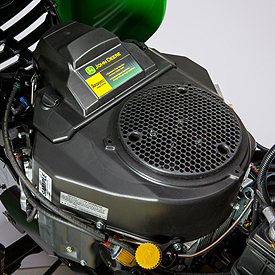 Smooth-running V-twin engine
Smooth-running V-twin engine
 Hood with vents for engine air
Hood with vents for engine air
The tractor is powered by a John Deere iTorque™ power system, a combination of engine features and an exclusive hood design providing superior lugging ability, even cooling, and durability. Key engine features include:
- 25.5 hp (19 kW) at 3500 rpm
- Large 726-cc displacement
- V-twin air-cooled design
- Excellent power and performance
- Smooth, quiet power
- Easy starts
- Quality features include:
- Cast-iron cylinder liners
- Overhead valves
- Full-pressure lubrication
- Replaceable oil filter
- Dual-stage air cleaner
- Solenoid-shift starter for easy starts, even in cold weather
Electronic fuel injection (EFI)
- EFI meters the correct amount of fuel directly into each engine cylinder for all operating conditions.
- It simplifies engine starts and warm-up by eliminating the need for the operator to use a choke.
- Fuel usage is reduced up to 10 percent compared to a carbureted engine.
Constant-speed governor
- Constant-speed governor works in conjunction with EFI to electronically adjust the supply of fuel air mixture, to increase torque as needed to maintain engine operating speed under load.
- Ground speed and mower blade-tip speed remain constant, even in heavy-grass conditions, to improve productivity and cut quality.
- Mechanical governors cannot respond fast enough to maintain a constant engine speed.
- Some torque rise remains to warn the operator before the engine stalls.
- X590's constant-speed governor is a first in the mowing industry.
Electronic fuel injection and constant-speed governor
 X590 Tractor dash, no choke required
X590 Tractor dash, no choke required
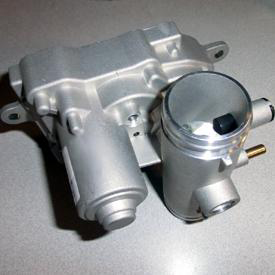 Electrically actuated air inlet valve
Electrically actuated air inlet valve
No choke control is needed for the EFI engine because a servo motor controls the intake air butterfly valve and the air stream. For cold starts the actuator will close the valve, making starting the engine easier - no choke lever is needed. Starts are quick and easy - even for inexperienced operators.
The advanced engine features provide the following advantages:
Constant-speed governor improves performance.
- Mowing time is reduced as the constant-speed governor keeps the engine operating at optimum speed, responding instantaneously as the mower transitions from light to heavy mowing.
- Cut quality is improved, especially in difficult mowing conditions, because the constant-speed governor keeps the mower blades turning at full speed, delivering optimal cut quality and dispersion of clippings. While snow blowing, maintaining the fan speed enables consistent snow placement.
EFI increases uptime.
- Fast, reliable starts are routine just like with a modern automobile. EFI automatically meters fuel, including the extra fuel needed to start a cold engine. Flooding by unnecessary choking of a warm engine is eliminated. No carburetor adjustments are needed at altitude.
- No choke-related problems since the choke is eliminated, thus ensuring operator confidence and quick starts, even in cold ambient temperatures (snow blower use). The mechanical throttle cable is replaced by an electric linkage that is not susceptible to wear or freezing.
Cost of ownership is reduced.
- EFI precisely meters fuel to each engine cylinder. Fuel usage can be expected to be about 10 percent less than with a similar carbureted tractor.
- Reduced maintenance expense because of fewer complaints related to hard starting, vapor lock, misfire, run-on, or fouled spark plugs.
The X590 Tractor, including the engine, is covered by a 4-year/500-hour bumper-to-bumper warranty*.
Flywheel alternator
A flywheel alternator provides plenty of capacity to quickly recharge the battery and power electrical equipment, such as lights or a sprayer:
- 15-amp capacity
- Regulated to keep the battery at a full charge, without risk of overcharging
*Term limited to years or hours used, whichever comes first, and varies by model. See the LIMITED WARRANTY FOR NEW JOHN DEERE TURF AND UTILITY EQUIPMENT at JohnDeere.com or JohnDeere.ca/TUWarranty for details.
Fuel tank has a large, 4.4-U.S. gal. (16.6-L) capacity
 Fuel tank
Fuel tank
Quality fuel system components enhance performance and convenience:
- Large, 4.4-U.S. gal. (16.6-L) capacity
- Wide, 3-in. (7.6-cm) diameter fuel tank filler opening
- Located on the left fender
- Makes adding fuel easy and helps eliminate spillage
- Sealed and tethered fuel cap
- Reduced fuel vapor loss
- Less chance of losing fuel cap
 Convenient dash-mounted fuel gauge
Convenient dash-mounted fuel gauge
- Automotive-style fuel gauge on the dash
- Easy to read from tractor seat
- Reduces likelihood of running out of fuel
- Eliminates unnecessary stops to refill
The 54-in. (137-cm) Accel Deep™ (54A) Mower Deck cuts clean and is versatile
 X394 with Accel Deep 54A Mower
X394 with Accel Deep 54A Mower
 Accel Deep 54A Mower
Accel Deep 54A Mower
The 54-in. (137-cm) Accel Deep Deck uses the latest in three-spindle mowing technology to raise performance to a higher level:
- 10-gauge, 0.135-in. (3.4-mm) deck stamping for long life
- Deep, flat-top deck design to handle a large volume of material at faster mowing speeds
- Gives excellent cut quality and uniform discharge
- Easy to keep clean on top of and under the deck
- Resilient four-point mounting system suspends mower from tractor for a smooth and level cut
- Wide mower wheels easily adjusted just above ground level to help prevent scalping
- 0.25-in. (6.4-mm) cut-height increments allow mower to be set at the desired cut height
- Onboard deck-leveling system makes keeping mower properly adjusted easy
- Compatible with optional MulchControl™ mulching system
- Compatible with high-performance Power Flow™ material collection systems
- For use on X380, X384, X390, X394, X570, X580, X584, and model year 2016 X590 Tractors
The 54-in. (137-cm) Accel Deep Mower Deck is a stamped-steel, deep, flat-top design that delivers excellent cut quality, productivity, cleanliness, durability, and versatility. Optimal performance and dispersion of clippings is provided, even at faster mowing speeds:
- 4.83-in. (12.3-cm) depth throughout the entire deck shell for optimum mowing, mulching, and bagging performance
- Optional lever-action or electric one-touch MulchControl attachment provides superior mulching performance and versatility.
- Stamped-steel design eliminates sharp edges and corners where material can build up and diminish mowing performance
- Mower deck is suspended from the vehicle for a smooth and level cut
- Adjustable mower wheels, positioned just above ground level, help reduce scalping
Excellent cut quality
 54A Mower top
54A Mower top
 54A Mower underside
54A Mower underside
Deep mower-deck stamping gives excellent cut quality. It allows the cut and suspended material room to exit the deck without getting recut:
- Reducing the amount of re-cutting enables more power to be used to cut incoming grass, which greatly improves mower capacity.
- Helps maintain excellent cut quality at faster mowing speeds
- Clean flow of material out of discharge area prevents cut material from interfering with cutting the incoming grass, making it possible for the blades to cut incoming material cleanly.
- Even in mulching mode, cut evenness is improved compared to other designs because the additional depth allows for continuous circulation, optimal re-cutting, and an even distribution of clippings.
Productivity - getting the job done fast
 Right side of Accel Deep 54A Mower Deck
Right side of Accel Deep 54A Mower Deck
Deep mower-deck stamping gives high productivity, which gets the job done fast. It allows the cut and suspended material room to exit the deck quickly, reducing the amount of re-cutting so more power is available to process incoming grass:
- Greatly improves mowers capacity to maintain excellent mowing performance in difficult mowing conditions and at higher speeds
Large discharge opening is both high and wide to handle more material:
- Gives a smooth, even discharge of clippings at all mowing speeds
- Reduces the chance of plugging, especially important when operating in wet, thick, or dense grass and when bagging
- The 54A Power Flow blower has an inlet housing with over 20 percent greater area than the 54X Power Flow blower used on previous machines.
Cleanliness - for the mower and the operator
 Accel Deep 54A Mower Deck
Accel Deep 54A Mower Deck
 Accel Deep 54A Mower Deck
Accel Deep 54A Mower Deck
The flat-top shape of the deck stamping is optimal for keeping itself and the operator clean:
- There are few places to catch and hold material on top and underneath the deck.
- Top of deck stays cleaner, reducing time and effort needed for cleaning and service
- Underside of deck is self-cleaning to maintain optimum performance without build-up of material to interfere with the flow of air and clippings
- Less need to clean and remove build-up of material from underside deck
- The depth of the Accel Deep mower deck minimizes the amount of material that escapes from the front of the deck:
- Limited amount of material to drift onto the operator and mower deck
- Even for material discharged out the chute, less re-cutting results in larger pieces that are less likely to end up on the operator
- Mulching prevents the discharge of material completely and a MulchControl attachment makes mulching a practical solution for most mowing situations.
Cleaning a mower deck, both top and bottom, is one of the most frequent maintenance activities:
- The flat-top design reduces places for material to build up and makes material that does collect easy to remove.
 Mower wash port
Mower wash port
 Mower wash port with hose connector
Mower wash port with hose connector
A wash port is provided to make cleaning the underside of the mower deck easy.
- Hose connector is included with the mower deck.
How MulchControl works
 MulchControl baffle open
MulchControl baffle open
 MulchControl baffle closed
MulchControl baffle closed
MulchControl is an innovative, simple design that is easy to use and maintain:
- The MulchControl attachment includes baffles to control the flow of material under the deck.
- The MulchControl baffle, or divider, between the left and middle spindles is about half way down. The height is designed to balance the mulch and side-discharge modes.
- When the MulchControl baffle is open, the divider between the left and middle spindles passes a portion of the material to the discharge opening, along with the material from the middle and right spindle areas.
- When the MulchControl baffle is closed, the material stays within the deck and gets chopped into mulch and deposited in the turf.
Superior durability is designed in
 Spindle pocket with flip-up cover
Spindle pocket with flip-up cover
 Easy-to-adjust mower wheel and mower side reinforcement
Easy-to-adjust mower wheel and mower side reinforcement
The 54A Mower Deck has strong spindle pockets, to keep the blades aligned, even after years of tough service:
- Ribs in the deck shell add strength where it is needed.
- The 54A has a 3 percent heavier overall weight than the Edge™ Xtra 54-in. (137-cm) mower deck used on previous machines.
Mower wheels are heavy duty:
- Provides greater strength and durability for longer, trouble-free life.
- Setting wheels to the correct height for the cutting height quick and easy.
Low-tension belt-drive design reduces the side load on engine lower bearings and mower deck bearings for longer life.
The 54A Mower Deck features a 5/8-in. (16-mm) diameter solid-steel rod side bumper that provides extra strength and protection.
Dual-stage E-coat and powder-paint coatings provide extra protection from rust.
Versatility - easy to change between side discharge, mulch, and bagging modes
The 54A Mower is designed for maximum versatility, providing the greatest ease in changing from one mower discharge mode to another:
- With an optional MulchControl attachment installed (along with the special mulching blades), changing from mulch mode to side discharge mode or vice versa is done with the simple flip of a lever or touch of an electric switch.
- The Power Flow rear bagger can be used with the MulchControl attachment and blades installed by simply using the MulchControl lever or electric one-touch switch to move the MulchControl baffle to the side-discharge position.
MulchControl option
A MulchControl attachment for the 54A Mower Deck makes mulching more practical for many mowing situations because it not only does an excellent job of mulching but it also allows the mower to be easily converted for times when it is more desirable to side discharge or collect the lawn material. Advantages of mulching grass clippings include:
- A beautiful looking lawn
- Grass clippings not blown onto the operator, driveways, or flower beds
- Less fertilizer use
- Elimination of the effort needed to dispose of clippings
 MulchControl handle
MulchControl handle
 Electric one-touch MulchControl switch
Electric one-touch MulchControl switch
- For the lever-action MulchControl attachment, the MulchControl lever on top of the mower deck is used to engage or disengage mulch mode.
- The operator is required to get off of the tractor in order to engage or disengage mulch mode with the lever-action system.
- For the electric one-touch MulchControl attachment, the electric switch on the tractor dash is used to engage or disengage mulch mode.
- Changing from mulch mode to side discharge mode or vice versa takes only a few seconds.
MulchControl is well-suited to the following mowing situations:
- Usually mulch, but side discharge when grass gets too long
- Usually side-discharge, but would like to be able to close the chute to control clippings
- Always mulch a main lawn, but often side discharge secondary lawns
- Bag clippings, but want to go farther before emptying bags
MulchControl puts the operator in control of the clippings. The operator can have all the benefits of mulching with the ability to easily change to side discharging or bagging when needed.
While in the side-discharge mode, MulchControl will still mulch about one third of the material. Therefore, the side-discharge mode is essentially a partial-mulch mode. This can be an advantage when side discharging or bagging, as it helps to reduce the amount of material being discharged. Other times this could work as a disadvantage:
- When cutting strong southern grasses, such as Zoysia and Bermuda
- When cutting in wet, high-growth conditions, such as those found in the Pacific Northwest United States
- When optimum bagging and lawn clean-up is desired
7-bu (247-L) Power Flow rear bagger
 Optional 7-bu (247-L) rear bagger
Optional 7-bu (247-L) rear bagger
 Power Flow blower
Power Flow blower
An optional 7-bu (247-L) rear bagger material collection system (MCS) is available. It provides an efficient means of collecting grass clippings and leaves:
- The Power Flow blower and chute are easy to install. The Power Flow blower swings out for easy cleanout and cleanup.
- The hopper design provides modern styling, great bagging performance, cleaner operation, and easy-to-empty bags:
- 7-bu (247-L) capacity
- Easy-to-attach Power Flow blower (ordered separately)
- Easy-to-attach chute (ordered separately)
- Air exhaust duct
- Convenient spring-latch
- Airflow fill indicator
- Quik-Tatch mounting
- Sealed hopper top
- Loose-knit bags available
Larger 14-bu (493-L) and 19-bu (670-L) MCS are available, in addition to the 7-bu (247-L) MCS, for specific X300 and X500 Series Tractor models.
Four-year or 500-hour bumper-to-bumper warranty is standard
An exclusive 4-year or 500-hour (whichever comes first), single-source, bumper-to-bumper warranty* is standard for all John Deere X500 Series Tractors.
- The warranty is hassle free, with one company handling all of the paperwork.
- Premium features of X500 Series Tractors allow for this longer warranty period, with more coverage than comparable tractors.
*Term limited to years or hours used, whichever comes first, and varies by model. See the LIMITED WARRANTY FOR NEW JOHN DEERE TURF AND UTILITY EQUIPMENT at JohnDeere.com or JohnDeere.ca/TUWarranty for details.
Power steering and hydraulic lift enable easy operation
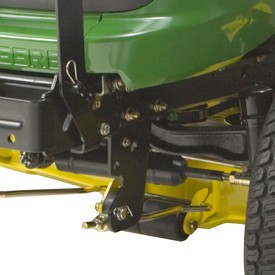 Power steering cylinder
Power steering cylinder
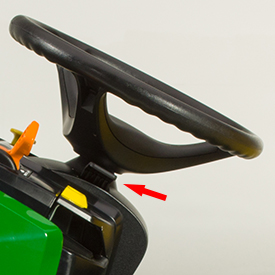 Tilt steering wheel control lever
Tilt steering wheel control lever
Hydraulic power steering is standard equipment:
- Provides effortless automotive-like control
- Reduces operator fatigue and increases productivity
- Offers a tight turning radius for great maneuverability
- Adjustable-tilt steering wheel for optimum operator comfort (X584 and X590)
Convenient hydraulic lift
 Hydraulic lift lever
Hydraulic lift lever
Convenient hydraulic lift lever makes raising and lowering the mower or implement easy:
- The hydraulic lift control lever is positioned on the dash near the steering wheel.
- Hydraulic lift provides quick, easy, and precise fingertip control of equipment.
- Implement float is built into the lift linkage.
Hydrostatic transaxle has traction assist
 Hydrostatic transaxle
Hydrostatic transaxle
 Piston-type rotating groups
Piston-type rotating groups
The integrated hydrostatic transaxle (IHT) encloses the hydrostatic pump and motor rotating groups in the same housing with the differential and axle housing:
- Very efficient piston-type design
- Fewer sealing surfaces to minimize potential for leakage
When combined with the foot controls, the hydrostatic transmission functions similarly to that of an automatic transmission in an automobile, so the term automatic is often used to describe it.
Key features of the drive system are as follows:
- Large pump and motor rotating groups for long life and efficient operation
- Full-length axle housings to support heavy loads
- Twin Touch™ foot control for easy and precise change of speed and direction
- Internal wet-disk brakes for long life and consistent operation. Brake interlock system that returns the foot control pedals to neutral during panic stops.
- Return mechanism that closes the freewheeling valve when the brake pedal is depressed to start the engine
- Replaceable oil filter for extra protection for tractors equipped with hydraulic lift and steering
 Replaceable filter (X580, X584, X590)
Replaceable filter (X580, X584, X590)
Standard cruise control
 Cruise control
Cruise control
Cruise control is standard equipment:
- Maintains a set tractor ground speed for mowing large areas or when driving the tractor from one location to another.
- Convenient, easy-to-use button to activate cruise control function.
- Release cruise control with brake pedal or forward Twin Touch™ foot pedal
Traction assist (differential lock)
 Traction assist control
Traction assist control
Traction assist is standard equipment:
- Traction assist supplies positive power to both drive wheels for increased traction.
- Foot-operated traction assist control is convenient for the operator to use, when needed.
Lever-action or electric one-touch MulchControl™ options are available for extra mowing convenience
 Lever-action MulchContol lever
Lever-action MulchContol lever
 Electric one-touch MulchControl switch
Electric one-touch MulchControl switch
Lever-action or electric one-touch MulchControl attachment is available for Accel Deep™ 42-in. (107-cm) (42A), 48-in. (122-cm) (48A), and 54-in. (137-cm) (54A) Mower Decks used on X300 and X500 Select Series™ Tractors.
MulchControl advantages and benefits
MulchControl enhances versatility and productivity. A mower deck equipped with MulchControl not only does an excellent job of mowing and mulching, but it can also be quickly converted from side discharging to mulching or vice versa:
- In mulch mode, it controls clippings dispersion in unwanted areas (driveways, landscape beds, near buildings, windows, parking lots, etc.).
- Reduces cleanup time needed to dispose of clippings.
- Reduces the amount of material entering a material collection system because, even in the side discharge mode, MulchControl will mulch about one third of the material due to the additional baffles under the mower deck and the unique design of the mulching blades.
Electric MulchControl has the additional advantage of being controlled from the tractor seat by a switch on the dash to operate an electric actuator that moves the baffle to close off the discharge area of the mower deck.
 Electric one-touch MulchControl switch
Electric one-touch MulchControl switch
 Electric one-touch MulchControl actuator
Electric one-touch MulchControl actuator
- Operators can convert between modes without interrupting the mowing process, making it practical to change between modes as conditions require.
- When approaching clean areas like driveways or flowerbeds where clippings would be undesirable
- When a breeze might blow clippings back onto the operator
- For side discharge mowing only the areas of the property where grass is too thick for mulching
- With 48A and 54A Mower Decks, for collecting only the areas of the property where grass is too tall or thick for mulching
- With 48A and 54A Mower Decks, the MulchControl baffle can be opened or closed with the Power Flow™ blower installed. The Power Flow blower will run without material when the baffle is closed.
- Models equipped with a 42A Mower Deck require a MulchControl baffle be removed to install the bagger chute; see 42A Mower Deck versatility explanation for more information.
- Changing from one mode to the other takes only a few seconds.
How MulchControl works
A mower equipped with a MulchControl attachment delivers unprecedented levels of productivity and versatility. The operator has the ability to quickly change between side discharging and mulching. A heavy-duty baffle opens and closes to convert the mower from side discharge mode to mulch mode or vice versa.
 MulchControl baffle open (similar mower deck shown)
MulchControl baffle open (similar mower deck shown)
 MulchControl baffle closed (similar mower deck shown)
MulchControl baffle closed (similar mower deck shown)
MulchControl is an innovative, simple design that is easy to use and maintain:
- The MulchControl attachment includes baffles to control the flow of material under the deck.
- When the MulchControl baffle is open, most of the material flows freely out the discharge deflector or into a material collection system.
- When the MulchControl baffle is closed, material stays within the deck and gets chopped into mulch and deposited in the turf.
MulchControl is well-suited to the following mowing situations:
- For operators who usually mulch, but side discharge when grass gets too long
- For operators who usually side discharge, but would like to be able to close the chute to control clippings in some areas
- For operators who always mulch a main lawn, but often side discharge secondary lawns
- For operators who collect clippings, but want to go farther before emptying the material collection system
MulchControl puts the operator in control of the clippings. The operator can have all the benefits of mulching with the ability to easily change to side discharging when desired.
Advantages of MulchControl include:
- Performance is improved.
- Mulching is beneficial because it returns the clippings to the ground as fertilizer, which promotes lawn growth.
- Clippings are much smaller, which allows them to fall into the grass and be removed from view.
- Unsightly grass clippings are not blown onto driveways or into flower beds.
- Fertilizer use is reduced and provides associated environmental benefits.
- Uptime is increased.
- Operators can convert quickly between modes, making it possible to change between mulching and side discharging as conditions require.
- Mulching heavy, thick material can significantly reduce mower productivity. The ability to switch from mulch to side discharge mode ensures productivity, especially in grass too tall or thick to mulch effectively.
- Cost of operation is reduced.
- Controlling clipping dispersion reduces cleanup time.
MulchControl limitations
While in the side discharge mode, MulchControl will still mulch about one third of the material. Therefore, the side discharge mode is essentially a partial mulch mode. This can be an advantage when side discharging or bagging, as it helps to reduce the amount of material being discharged. Other times this could work as a disadvantage:
- When cutting strong southern grasses, such as Zoysia and Bermuda
- When cutting in wet, high growth conditions, such as those found in the Pacific Northwest United States
- When optimum bagging and lawn cleanup is desired
- 42A Mower Deck requires a MulchControl baffle be removed to install the bagger chute
Lever-action MulchControl attachments
| Attachment number | Description | Applications |
| BM24794 | 42A MulchControl (lever action) | X300 Series Tractors, Z300 Series ZTrak™ Mowers |
| BM24993 | 48A MulchControl (lever action) | X300 and X500 Series Tractors, Z300 and Z500 Series ZTrak Mowers |
| BM24994 | 54A MulchControl (lever action) | X300 and X500 Series Tractors, Z300 and Z500 Series ZTrak Mowers |
Electric one-touch MulchControl attachments
| Attachment number | Description | Applications |
| BUC10164 | 42A electric one-touch MulchControl | X300 Series Tractors* |
| BUC10165 | 48A electric one-touch MulchControl | X300 and X500 Series Tractors* |
| BUC10166 | 54A electric one-touch MulchControl | X300 and X500 Series Tractors* |
* NOTE: Model year 2016-2017 X300 and X500 Series Tractors (X300 serial number 10,001-50,000 and X500 serial number 110,001-130,000) require replacing the tractor wiring harness and dash panel to use an electric MulchControl attachment.
MulchControl compatibility
Each MulchControl attachment includes everything needed: baffles and mulch blades for all attachments, and the actuator, wiring, and switches for the electric one-touch attachments.
Snow removal and yard care is a strength of lawn tractors
 X590 Tractor shown with optional front blade and weather enclosure
X590 Tractor shown with optional front blade and weather enclosure
 X590 Tractor shown with optional snow blower and weather enclosure
X590 Tractor shown with optional snow blower and weather enclosure
An advantage of lawn tractors is their ability to use attachments for snow removal and other yard-care chores. Lawn tractor owners can add a John Deere snow blower or front blade to make quick work of moving snow whenever the need arises. Weather enclosure and tire-chain attachments add comfort and performance.
Equipment available for snow removal includes:
- 44-in. (112-cm) Snow Blower for X570 Tractor
- 47-in. (119-cm) Snow Blower for X580, X584, and X590 Tractors
- 48-in. (122-cm) Front Blade
- Tire chains or TerraGrip traction belts
- Weather enclosure
- Weights
 30-in. (76-cm) Mechanical Rotary Tiller
30-in. (76-cm) Mechanical Rotary Tiller
 42-in. (107-cm) Hydraulic Rotary Tiller
42-in. (107-cm) Hydraulic Rotary Tiller
Rotary tillers are real time savers for preparing seedbeds, controlling weeds, and other tillage jobs.
Equipment available for tilling includes:
- 30-in. (76-cm) Mechanical Rotary Tiller for X570, X580, and X590 Tractors
- 42-in. (107-cm) Hydraulic Rotary Tiller for X580 and X590 Tractors
- The hydraulic tiller is quieter operating and has the unique ability to operate with either forward or reverse tine rotation.
- Weights
Control and display functions are easy to identify and convenient to use
 Controls and gauges (steering wheel removed)
Controls and gauges (steering wheel removed)
 Dash (X590 Tractor shown with switch on to show display)
Dash (X590 Tractor shown with switch on to show display)
Controls
The contoured dash has clean, attractive styling and ergonomic controls for easy use:
- Controls are color-coded for easy identification by the operator.
- Controls are logically placed and easy to reach.
- The power take-off (PTO) switch allows the operator to get fingers underneath it, like a T-handle, to pull up for easy activation.
- The reverse implement option (RIO) switch is a yellow button.
- The latch control on foot-lift models and hydraulic-lift control on power-lift models and the park brake latch are pivot levers for low effort.
- Cruise control activation is handled by an automotive-style button.
- Separate engine speed and choke controls make starting and warming up the engine easier in cold weather.
- The choke lever is spring loaded to eliminate the chance the tractor will be unintentionally operated with the choke partially closed.
- Functional design of the throttle and choke controls provides good appearance and a comfortable feel.
Display panel
 Display panel
Display panel
 Display panel illustration with descriptions
Display panel illustration with descriptions
Instrument display has the look and feel of a modern automobile. A power-up sequence cycles lights and gauges to indicate they are working:
- Display features dark-cockpit design to minimize operator distractions.
- Display is back lit for night visibility.
- Night visibility is especially useful with snow blower use.
- Hour meter makes it easy to tell when oil changes and other maintenance should be performed.
- Electronic fuel gauge provides real-time fuel level information.
- A tachometer graphically displays engine speed.
- Target-zone graphics inform the operator of the engine speed range to use for best cut quality.
- An indicator tells the operator when the PTO is operating.
- Bright caution and stop lights capture the operator's attention when important information is on the instrument cluster.
- Damage can be prevented and repair costs reduced by addressing problems early.
- Operators are advised of what the problem is if they attempt to operate the mower with unsatisfied PTO, seat, or park brake interlocks.
- The indicators are also useful to identify the reasons the PTO or engine may have shut off when an interlock is unsatisfied.
- Operators are advised if battery voltage is low, normal, or excessive.
- The service indicator light illuminates to indicate a diagnostic error code is stored.
- On-board diagnostics provides trouble codes for use by trained technicians.
- For example, a technician will be able to test switch functionality and circuit continuity without tools.
- On-board diagnostics provides trouble codes for use by trained technicians.
Twin Touch™ foot control
 Twin Touch foot control
Twin Touch foot control
 Cruise control
Cruise control
Twin Touch foot pedals control the speed and direction of travel:
- Automotive-type accelerator control ensures easy operation.
- Operator can change direction without lifting foot off the platform.
- Large pedal surface gives superior operator comfort.
Cruise control
Cruise control is standard equipment:
- To engage, push the cruise-control button and hold until the foot is removed from the forward pedal.
- For emergency stop, the cruise control can be released by pushing on the brake pedal or the forward pedal.
Convenient hydraulic lift (X580, X584, X590)
 Hydraulic lift lever (X580, X584, X590)
Hydraulic lift lever (X580, X584, X590)
Convenient hydraulic lift lever makes raising and lowering the mower or implement easy:
- The hydraulic lift control lever is positioned on the dash near the steering wheel.
- Hydraulic lift provides quick, easy, and precise fingertip control of equipment.
- Implement float is built into the lift linkage.
Mower deck height adjustment
 Conveniently located mower deck height adjustment
Conveniently located mower deck height adjustment
 Onboard mower adjusting gauge and wrench
Onboard mower adjusting gauge and wrench
A rotary dial knob makes adjusting the mower cut height quick and easy:
- Mower cut height can be adjusted in 0.25-in. (6.4-mm) increments from 1 in. (2.5 cm) to 4 in. (10.2 cm).
- Mower deck returns to the same preset height each time it is lowered.
- Onboard deck-leveling gauge and Exact Adjust tool conveniently located in the storage compartment under the seat
- Used in conjunction with Exact Adjust ports for easy and accurate leveling of the mower deck for optimum mowing performance
 Deck-leveling gauge placed under deck
Deck-leveling gauge placed under deck
 Exact Adjust tool is used to level mower deck
Exact Adjust tool is used to level mower deck
Storage for the onboard deck-leveling gauge and the Exact Adjust tool is provided in the storage tray under the tractor’s seat:
- Exact Adjust ports allow for easy and accurate leveling of the mower deck for optimum mowing performance.
Deck-leveling gauge is placed at the appropriate location under the left rear, right rear, and front of the mower deck as the cut height is adjusted using the Exact Adjust tool and front draft arm adjusting nuts.
Foot pedal lift system (X570)
 Foot pedal lift system (X570)
Foot pedal lift system (X570)
 Foot-lift latch control
Foot-lift latch control
Pushing with the foot to raise the mower or implement is less strenuous for many operators:
- Easy-to-use raised-position lock operates similarly to the park brake lock.
- Foot pedal is out of the way and not likely to catch on bushes and tree limbs when mowing.
- Mower deck returns to the same preset height each time it is lowered.
 Lift-spring decals and bolt
Lift-spring decals and bolt
 Lift-assist spring decal
Lift-assist spring decal
A lift-assist spring is provided on the tractor to minimize lift effort:
-
Lift effort can be easily adjusted by just turning a bolt located on the tractor front bumper for optimum performance, depending on the equipment used (mower, front blade, etc.).
-
Decals on the outside of the tractor frame indicate appropriate adjustment.
-
The mower will not be inadvertently locked in the raised position when mowing through ditches.
-
When installing or removing a mower or front equipment raised by the foot-lift system, spring tension may be removed from the connection points.
-
Pull rearward on the lift pedal and raise the lift latch to hold the pedal in the rearward position.
-
Parking brake control
 Parking brake
Parking brake
Depressing the brake pedal applies force to internal wet-disk brake (which provides excellent durability and long life) for safe stopping.
Parking brake control is conveniently located for easy access; holds brake pedal securely in locked position.
Electric power take-off (PTO) clutch is easy and convenient to use
 Electric PTO switch
Electric PTO switch
The heavy-duty electric PTO clutch is operated with a convenient dash-mounted switch.
Heavy-duty PTO clutch
 PTO clutch
PTO clutch
The PTO clutch is designed to operate through many on/off cycles.
RIO
 Reverse implement switch
Reverse implement switch
Using RIO
CAUTION: Children or bystanders may be injured by rotating blades. Before traveling forward or rearward:
- Carefully check the area around the machine.
- Disengage the mower before backing up.
NOTE: Operating the mower while backing up is strongly discouraged. RIO should be used only when operating another attachment or when the operator deems it necessary to reposition the machine with the mower engaged.
- Stop forward travel. Allow attachment to run.
- Look down and behind the machine to be sure that there are no bystanders.
- Push and hold in the reverse implement switch while depressing the reverse pedal slightly.
NOTE: If the attachment stops while positioning the machine, return mower engagement (PTO) switch to off position. Repeat this procedure from the beginning. - Release the reverse implement switch and reposition the machine as the machine begins to move rearward.
- Resume forward travel. The attachment should continue operating.
- Repeat procedure to position the machine again.
Frame is formed from thick steel and welded for reliability
 Heavy-duty welded frame
Heavy-duty welded frame
 Front bumper/weight bracket
Front bumper/weight bracket
The frame is made of heavy-duty formed and welded steel, reinforced in critical areas for even greater strength:
- Frame is formed from 12-gauge, 0.105-in. (2.66-mm) thick material.
- Front bumper and hitch plate are formed from 0.25-in. (6.4-mm) steel and complete the frame assembly.
- Front bumper can support up to four 42-lb (19-kg) Quik-Tatch weights.
- Rear hitch plate can support up to four 42-lb (19-kg) Quik-Tatch weights.
- X584 requires an optional rear weight bracket.
Optional Quik-Tatch weights
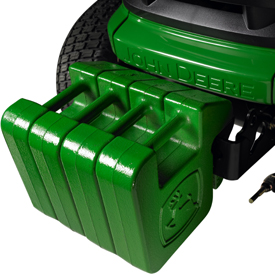 Shown with four optional 42-lb (19-kg) Quik-Tatch weights
Shown with four optional 42-lb (19-kg) Quik-Tatch weights
The front bumper holds up to four 42-lb (19-kg) Quik-Tatch weights.
Front axle and wheel spindles are heavy duty
 Cast-iron front axle
Cast-iron front axle
The front axle is made of nodular cast iron:
- Strong and shock resistant
- Will not yield under heavy loads or impact
Replaceable bushings are used at the center axle pivot and steering spindles:
- Provide excellent wear resistance
- Grease cavity between bushings maintains lubrication and easy steering between greasings
- Easy-to-service grease fittings at each spindle
Front steering spindles
 Steering spindle (X570 shown)
Steering spindle (X570 shown)
The front steering spindles are strong for long life:
- Have the strength to handle heavy implements
- 0.75-in. (19-mm) steering spindle diameter (X570)
- 1-in. (25.4-mm) steering spindle diameter (X580, X584, X590)
- Provide long life at bearing surfaces
- 0.75-in. (19-mm) diameter front wheel bearings (X570)
- 1-in. (25.4-mm) diameter front wheel bearings (X580, X584, X590)
- Sealed precision ball bearings at front wheels ensure long life and are maintenance free
Rear equipment-mounting system is heavy-duty and easy to use
 Rear equipment mounting system
Rear equipment mounting system
A heavy-duty equipment mounting system is used:
- Includes strong frame mounts with a combination of mounting holes in the tractor hitch plate that accept pins or shoulder bolts to support heavy rear-mounted equipment.
- Easily attach optional equipment to the tractor
- Can bear the load of heavy rear-mounted equipment, such as material collection systems
Modern styling is eye appealing and functional
 Attractive styling
Attractive styling
 Side-hood vents
Side-hood vents
Smooth, rounded contours present a modern, styled appearance:
- Hood styling incorporates efficient full-length air-intake louvers on each side.
- Cooler engine operation
- Lower operator station sound levels
- Hot air is vented out the front grill, away from the operator.
- The fully enclosed hood is made of molded-in-color material.
- Reduces sound
- Will not rust or dent
- Distinctive grille and large, one-piece fender deck complete the styling package.
Versatility and premium features for great performance with larger equipment
 X590 show with 47-in. (119-cm) Snow Blower
X590 show with 47-in. (119-cm) Snow Blower
 X590 Tractor shown
X590 Tractor shown
Premium features ensure the versatility of X500 Series Tractors:
- Heavy-duty welded-steel frame with integrated rear weight bracket
- Integrated front weight bracket (X580, X584, X590)
- Air-cooled John Deere iTorque™ power system
- Differential lock
- Convenient foot-pedal lift system (X570) or easy-to-use hydraulic lift (X580, X584, X590)
- Low-effort manual steering (X570) or power steering (X580, X584, X590)
- Five-position tilt steering wheel (X584, X590)
- Heavy-duty all-purpose (HDAP) rear tires (X580, X590)
- Accel Deep™ Mower Decks with optional MulchControl™ system
Two headlights give excellent visibility
 Quality headlights
Quality headlights
Headlights are standard equipment.
High-quality headlights make evening work easier and safer:
- Two 27-W bulbs provide excellent lighting for improved visibility during evening operation.
- A headlight position on the ignition switch makes it easy to operate the headlights.
- Headlights are designed to provide an optimum lighting pattern for mowing and snow removal.
Operator station is comfortable and convenient
 Dash controls are color coded for identification
Dash controls are color coded for identification
 Automotive-like dash display
Automotive-like dash display
The operator station is designed for operator comfort and convenience in operating all controls. The controls are easy to use and color coded for quick identification.
Comfortable seats
 15-in. (38-cm) open-back seat (X570, X580)
15-in. (38-cm) open-back seat (X570, X580)
 21-in. (53-cm) high-back seat (X584, X590)
21-in. (53-cm) high-back seat (X584, X590)
The 15-in. (38-cm) open-back seat (X570, X580) features distinctive styling and is designed for comfort:
- Open-back design allows air circulation to keep the operator's back cool and dry for a more comfortable ride.
- Hand grip at the top of the seat is conveniently located for use when tilting the seat up to protect it from the weather.
The 21-in. (53-cm) high-back seat (X584, X590) provides additional comfort and support for the operator.
Adjustable suspension
 Seat shown with optional storage pocket
Seat shown with optional storage pocket
The seat suspension is easily adjusted to make most any operator comfortable:
- 7 in. (18 cm) of seat travel allows the operator to be seated comfortably and operate the controls easily.
- Seat can be easily adjusted fore and aft by the operator while sitting on the seat (15 positions).
- Seat features a suspension that is easily adjusted for the operator's weight and height.
- Springs provide a smooth ride and will not bottom out.
- Spring position is adjustable for the operator's weight.
- Seat tilts forward to keep the seating surface out of the weather.
- Tilting the seat forward keeps moisture and the sun off the seat cushion for greater operator comfort.
- Optional storage pocket (X570, X580) provides a convenient storage area for gloves, etc.
Optional 21-in. (53.3-cm) professional two-piece seat, four-bar suspension, and slide
 Seat has convenient tilt-back feature
Seat has convenient tilt-back feature
 Tilt-back seat control
Tilt-back seat control
The optional 21-in. (53.3-cm) professional two-piece seat, four-bar suspension, and slide shipped on Signature Series X700 Tractors is available as an upgrade seat and suspension for all X500 Multi-Terrain Tractors (model year 2006-). Key selling features for this seat include:
- Thick seat cushion for lasting comfort, even after a full day of use
- Back of seat can be angled to maximize operator comfort
- Convenient lever on the side of the seat unlocks back of seat to allow positioning
- Four-bar suspension and slide are included for extra comfort and bolt to the tractors fender-deck mounting holes
- BM24426 armrest attachment available as a field-installed option
Optional armrest attachment
 Adjustable armrest option
Adjustable armrest option
 Left armrest in raised position
Left armrest in raised position
Armrests increase operator support and comfort, thus reducing fatigue and improving productivity, especially when mowing for extended periods of time. Armrests are adjustable to suit the operator. This armrest attachment is designed for the optional 21-in. (53.3-cm) professional two-piece seat.
Tilt steering wheel (X584, X590)
 Tilt steering wheel (lowest position)
Tilt steering wheel (lowest position)
 Tilt steering wheel (highest position)
Tilt steering wheel (highest position)
- Five steering-wheel positions allow the operator to select the most comfortable setting (X584, X590).
Rubber foot pads
 Rubber foot pads
Rubber foot pads
Rubber foot pads make the operator more comfortable:
- Help insulate operator's feet from vibration
- Attractive styling
- Long-lasting wear surface
- Reduce chance of slippage, even with wet surface
 Cup holder, toolbox, and fender handle
Cup holder, toolbox, and fender handle
A cup holder and covered toolbox are conveniently located on the fender next to the operator's seat.
Handles on each fender are useful when getting on and off the tractor.
 Standard 12-V outlet
Standard 12-V outlet
A 12-V outlet is standard equipment and provides a convenient plug-in for electrical equipment.
 Illustration of fast connector location
Illustration of fast connector location
A mid-vehicle 12-V fast connector, located under the tractor’s fuse box, is included as standard equipment to reduce initial installation time for some attachments that operate on 12-V power from the tractor:
- The four-cavity connector includes battery, ground, and key switch terminals and is turned on and off with the ignition switch.
Serviceability is convenient with easy-open hood
 One-piece hood is easy to open
One-piece hood is easy to open
 Service interval decal located under hood
Service interval decal located under hood
The one-piece hood opens easily to permit checking and servicing the engine:
- Important service points are located within easy reach.
- A service-interval decal is provided inside the tractor hood for convenience when servicing the tractor.
- The high-quality engine used in the X500 Series does not require an 8-hour oil and filter change because improvements in manufacturing processes and quality of parts, components, and oils have eliminated the need for the short interval oil change requirement.
 Easy-to-service engine fuel and oil filters
Easy-to-service engine fuel and oil filters
The engine fuel and oil filters, the oil check/fill tube, and the oil drain tube are exposed for serviceability when the hood is opened.
Exact Adjust ports and onboard deck-leveling tools make precise deck adjustments easy
 Deck-leveling gauge and hex adjusting tool stored under tractor seat
Deck-leveling gauge and hex adjusting tool stored under tractor seat
 Exact Adjust access holes
Exact Adjust access holes
A mower deck must be level side-to-side and properly adjusted front-to-rear to give the best cutting performance. A removable onboard deck-leveling gauge and a hex-key tool are provided to make adjustment easy. They are securely stored under the tractor seat.
Exact Adjust leveling ports are provided on each side of the operator platform above the mower-level adjusting bolts. With the hex-shaped tool, they provide convenient access to allow quick and easy adjustment of the mower for the best-cut quality of cut.
The Exact Adjust feature is standard on all Select Series™ X300 and X500 Tractors:
- There is no need to reach under the fender deck while making the mower-level adjustment.
- Onboard deck-leveling gauge, Exact Adjust ports, and the hex tool work together.
- Level the mower deck side to side
- Set the correct amount of rake (front-to-back deck orientation)
- Calibrate the cutting height to the cut-height adjusting knob setting
- Exact Adjust simplifies leveling the mower deck if equipped with a Power Flow™ blower.
- To give the best cut, mower level should be adjusted if alternately mowing with and without blower installed. The Exact Adjust feature makes this easy.
 Deck-leveling tool placed under deck
Deck-leveling tool placed under deck
 Using included ball-hex tool to level mower deck
Using included ball-hex tool to level mower deck
Consult the operator's manual for the correct adjusting procedures for each tractor model. Basic adjusting steps to properly level the mower deck include:
- Park the tractor on a level surface.
- Inflate tires to the correct pressure.
- Consult the label for the cutting-height knob that is located on the console of the machine. This label shows deck-leveling position and location of deck-leveling adjustment points.
 Cut height adjusting knob
Cut height adjusting knob
- Set mower cutting-height knob to the correct deck-leveling position.
- For X300 models, use position 2.75
- For all other models, use position 2.5
- Adjust mower wheels as necessary so they do not contact the ground surface.
- Remove the onboard deck-leveling gauge that is located under the seat.
- Using the Exact Adjust ports and tool, adjust mower deck side-to-side level so the deck-leveling gauge just slips under the left and right lower deck rim at the designated adjustment points. The location of adjustment points will vary slightly between decks.
- Left- and right-rear adjustment points are under the deck rim near the rear mower wheels, if equipped.
- Adjust mower deck front-to-back level, if necessary.
- Loosen rear nuts equally on each side of front lift rod.
- Turn front nut equally on each side clockwise to raise front of mower or counterclockwise to lower it until gauge just slips under the front adjustment point.
- Tighten rear nuts after adjustment is complete.
- Return the gauge to its storage position.
NOTE: The adjusting tool supplied with the tractor is an 8-mm ball-hex key, part number M162737. The rounded end allows for some misalignment with the bolt as the deck is adjusted.
The MowerPlus™ app helps maintain the tractor and lawn
 MowerPlus app screen
MowerPlus app screen
 MowerPlus app maintenance screen
MowerPlus app maintenance screen
Keep a John Deere riding lawn mower running its best and know how it mows with the John Deere MowerPlus app. Simply scan the lawn tractor’s barcode to get custom information. The app helps determine the best time to mow, communicates expert pre-mow tips, offers maintenance reminders, and provides walk-through guides.
Look for the MowerPlus app on the mobile device’s app store.
The app supports residential lawn equipment such as 100 Series, S240, X300, X500, X700, Z200 through Z600, and many similarly-sized older products. It does not presently support tractor models numbered 1000 and larger, such as 1025R.
NOTE: Some product image variation may exist.
Also available is the John Deere MowerPlus smart connector (sold separately).
 Smart connector
Smart connector
The John Deere MowerPlus smart connector wirelessly links a Select Series™ X300 or X500 Tractor to the MowerPlus app on a mobile device. The smart connector transmits engine usage to the app, making it easy to track maintenance intervals. It also transmits the fuel level to the app—when thinking ahead about Saturday morning mowing, the operator can make sure the tractor is fueled and ready to go.
Features
V-twin engine has electronic fuel injection (EFI) and constant-speed governor for quick starts and superior performance
 Smooth-running V-twin engine
Smooth-running V-twin engine
 Hood with vents for engine air
Hood with vents for engine air
The tractor is powered by a John Deere iTorque™ power system, a combination of engine features and an exclusive hood design providing superior lugging ability, even cooling, and durability. Key engine features include:
- 25.5 hp (19 kW) at 3500 rpm
- Large 726-cc displacement
- V-twin air-cooled design
- Excellent power and performance
- Smooth, quiet power
- Easy starts
- Quality features include:
- Cast-iron cylinder liners
- Overhead valves
- Full-pressure lubrication
- Replaceable oil filter
- Dual-stage air cleaner
- Solenoid-shift starter for easy starts, even in cold weather
Electronic fuel injection (EFI)
- EFI meters the correct amount of fuel directly into each engine cylinder for all operating conditions.
- It simplifies engine starts and warm-up by eliminating the need for the operator to use a choke.
- Fuel usage is reduced up to 10 percent compared to a carbureted engine.
Constant-speed governor
- Constant-speed governor works in conjunction with EFI to electronically adjust the supply of fuel air mixture, to increase torque as needed to maintain engine operating speed under load.
- Ground speed and mower blade-tip speed remain constant, even in heavy-grass conditions, to improve productivity and cut quality.
- Mechanical governors cannot respond fast enough to maintain a constant engine speed.
- Some torque rise remains to warn the operator before the engine stalls.
- X590's constant-speed governor is a first in the mowing industry.
Electronic fuel injection and constant-speed governor
 X590 Tractor dash, no choke required
X590 Tractor dash, no choke required
 Electrically actuated air inlet valve
Electrically actuated air inlet valve
No choke control is needed for the EFI engine because a servo motor controls the intake air butterfly valve and the air stream. For cold starts the actuator will close the valve, making starting the engine easier - no choke lever is needed. Starts are quick and easy - even for inexperienced operators.
The advanced engine features provide the following advantages:
Constant-speed governor improves performance.
- Mowing time is reduced as the constant-speed governor keeps the engine operating at optimum speed, responding instantaneously as the mower transitions from light to heavy mowing.
- Cut quality is improved, especially in difficult mowing conditions, because the constant-speed governor keeps the mower blades turning at full speed, delivering optimal cut quality and dispersion of clippings. While snow blowing, maintaining the fan speed enables consistent snow placement.
EFI increases uptime.
- Fast, reliable starts are routine just like with a modern automobile. EFI automatically meters fuel, including the extra fuel needed to start a cold engine. Flooding by unnecessary choking of a warm engine is eliminated. No carburetor adjustments are needed at altitude.
- No choke-related problems since the choke is eliminated, thus ensuring operator confidence and quick starts, even in cold ambient temperatures (snow blower use). The mechanical throttle cable is replaced by an electric linkage that is not susceptible to wear or freezing.
Cost of ownership is reduced.
- EFI precisely meters fuel to each engine cylinder. Fuel usage can be expected to be about 10 percent less than with a similar carbureted tractor.
- Reduced maintenance expense because of fewer complaints related to hard starting, vapor lock, misfire, run-on, or fouled spark plugs.
The X590 Tractor, including the engine, is covered by a 4-year/500-hour bumper-to-bumper warranty*.
Flywheel alternator
A flywheel alternator provides plenty of capacity to quickly recharge the battery and power electrical equipment, such as lights or a sprayer:
- 15-amp capacity
- Regulated to keep the battery at a full charge, without risk of overcharging
*Term limited to years or hours used, whichever comes first, and varies by model. See the LIMITED WARRANTY FOR NEW JOHN DEERE TURF AND UTILITY EQUIPMENT at JohnDeere.com or JohnDeere.ca/TUWarranty for details.
Fuel tank has a large, 4.4-U.S. gal. (16.6-L) capacity
 Fuel tank
Fuel tank
Quality fuel system components enhance performance and convenience:
- Large, 4.4-U.S. gal. (16.6-L) capacity
- Wide, 3-in. (7.6-cm) diameter fuel tank filler opening
- Located on the left fender
- Makes adding fuel easy and helps eliminate spillage
- Sealed and tethered fuel cap
- Reduced fuel vapor loss
- Less chance of losing fuel cap
 Convenient dash-mounted fuel gauge
Convenient dash-mounted fuel gauge
- Automotive-style fuel gauge on the dash
- Easy to read from tractor seat
- Reduces likelihood of running out of fuel
- Eliminates unnecessary stops to refill
The 48-in. (122-cm) Accel Deep™ (48A) Mower Deck cuts clean and is versatile
 X394 with Accel Deep 48A Mower
X394 with Accel Deep 48A Mower
 Accel Deep 48A Mower
Accel Deep 48A Mower
The 48-in. (122-cm) Accel Deep Deck uses the latest in three-spindle mowing technology to raise performance to a higher level:
- 10-gauge, 0.135-in. (3.4-mm) deck stamping for long life
- Deep, flat-top deck design to handle a large volume of material at faster mowing speeds
- Gives excellent cut quality and uniform discharge
- Easy to keep clean on top of and under the deck
- Resilient four-point mounting system suspends mower from tractor for a smooth and level cut
- Wide mower wheels easily adjusted just above ground level to help prevent scalping
- 0.25-in. (6.4-mm) cut-height increments allow mower to be set at the desired cut height
- Onboard deck-leveling system makes keeping mower properly adjusted easy
- Compatible with optional MulchControl™ mulching system
- Compatible with high-performance Power Flow™ material collection systems
- For use on X330, X350, X354, X370, X380, X384, X390, X394, X570, X580, X584, and model year 2016 X590 Tractors
The 48-in. (122-cm) Accel Deep Mower Deck is a stamped-steel, deep, flat-top design that delivers excellent cut quality, productivity, cleanliness, durability, and versatility. Optimal performance and dispersion of clippings is provided, even at faster mowing speeds:
- 4.83-in. (12.3-cm) depth throughout the entire deck shell for optimum mowing, mulching, and bagging performance
- Optional lever-action or electric one-touch MulchControl attachment provides superior mulching performance and versatility.
- Stamped-steel design eliminates sharp edges and corners where material can build up and diminish mowing performance
- Mower deck is suspended from the vehicle for a smooth and level cut
- Adjustable mower wheels, positioned just above ground level, help reduce scalping
Excellent cut quality
 48A Mower top (similar mower from X700 Series Tractor shown)
48A Mower top (similar mower from X700 Series Tractor shown)
 48A Mower underside (similar mower from X700 Series Tractor shown)
48A Mower underside (similar mower from X700 Series Tractor shown)
Deep mower-deck stamping gives excellent cut quality. It allows the cut and suspended material room to exit the deck without getting recut:
- Reducing the amount of re-cutting enables more power to be used to cut incoming grass, which greatly improves mower capacity.
- Helps maintain excellent cut quality at faster mowing speeds
- Clean flow of material out of discharge area prevents cut material from interfering with cutting the incoming grass, making it possible for the blades to cut incoming material cleanly.
- Even in mulching mode, cut evenness is improved compared to other designs because the additional depth allows for continuous circulation, optimal re-cutting, and an even distribution of clippings.
Productivity - getting the job done fast
 Right side of Accel Deep 48A Mower Deck
Right side of Accel Deep 48A Mower Deck
Deep mower-deck stamping gives high productivity, which gets the job done fast. It allows the cut and suspended material room to exit the deck quickly, reducing the amount of re-cutting so more power is available to process incoming grass:
- Greatly improves mowers capacity to maintain excellent mowing performance in difficult mowing conditions and at higher speeds
Large discharge opening is both high and wide to handle more material:
- Gives a smooth, even discharge of clippings at all mowing speeds
- Reduces the chance of plugging, especially important when operating in wet, thick, or dense grass and when bagging
- The 48A Power Flow blower has an inlet housing with over 50 percent greater area than the 48X Power Flow blower used on previous machines.
Cleanliness - for the mower and the operator
 Accel Deep 48A Mower Deck
Accel Deep 48A Mower Deck
 Accel Deep 48A Mower Deck
Accel Deep 48A Mower Deck
The flat-top shape of the deck stamping is optimal for keeping itself and the operator clean:
- There are few places to catch and hold material on top and underneath the deck.
- Top of deck stays cleaner, reducing time and effort needed for cleaning and service
- Underside of deck is self-cleaning to maintain optimum performance without buildup of material to interfere with the flow of air and clippings
- Less need to clean and remove buildup of material from underside deck
- The depth of the Accel Deep mower deck minimizes the amount of material that escapes from the front of the deck:
- Limited amount of material to drift onto the operator and mower deck
- Even for material discharged out the chute, less re-cutting results in larger pieces that are less likely to end up on the operator
- Mulching prevents the discharge of material completely and the MulchControl attachment makes mulching a practical solution for most mowing situations.
 Mower wash port
Mower wash port
 Mower wash port with hose connector
Mower wash port with hose connector
A wash port is provided to make cleaning the underside of the mower deck easy.
- Hose connector is included with the mower deck.
Versatility - easy to change between side discharge, mulch, and bagging modes
The 48A Mower is designed for maximum versatility, providing the greatest ease in changing from one mower discharge mode to another:
- With an optional MulchControl attachment installed (along with the special mulching blades), changing from side-discharging to mulching or vice versa is done with the simple flip of a lever or push of an electric switch.
- The Power Flow rear bagger can be used with the MulchControl attachment and blades installed by simply using the MulchControl lever or electric one-touch switch to move the mulch baffle to the side-discharge position.
How MulchControl works
 MulchControl baffle open
MulchControl baffle open
 MulchControl baffle closed
MulchControl baffle closed
MulchControl is an innovative, simple design that is easy to use and maintain:
- The MulchControl attachment includes baffles to control the flow of material under the deck.
- The MulchControl baffle, or divider, between the left and middle spindles is about half way down. The height is designed to balance the mulching and side-discharge modes.
- When the MulchControl baffle is open, the divider between the left and middle spindles passes a portion of the material to the discharge opening, along with the material from the middle and right spindle areas.
- When the MulchControl baffle is closed, the material stays within the deck and gets chopped into mulch and deposited in the turf.
Cleaning a mower deck, both top and bottom, is one of the most frequent maintenance activities:
- The flat-top design reduces places for material to build up and makes material that does collect easy to remove.
Superior durability is designed in
 Spindle pocket with flip-up cover
Spindle pocket with flip-up cover
 Easy-to-adjust mower wheel and mower side reinforcement
Easy-to-adjust mower wheel and mower side reinforcement
The 48A Mower Deck has strong spindle pockets, to keep the blades aligned, even after years of tough service:
- Ribs in the deck shell add strength where it is needed.
- The 48A has a 23 percent heavier overall weight than the Edge™ Xtra 48-in. (122-cm) mower deck used on previous machines.
Mower wheels are heavy duty:
- Provides greater strength and durability for longer, trouble-free life.
- Setting wheels to the correct height for the cutting height quick and easy.
Low-tension belt-drive design reduces the side load on engine lower bearings and mower deck bearings for longer life.
The 48A Mower Deck features a 5/8-in. (16-mm) diameter solid-steel rod side bumper that provides extra strength and protection.
Dual-stage E-coat and powder-paint coatings provide extra protection from rust.
MulchControl option
A lever-action or electric one-touch MulchControl attachment for the 48A Mower Deck makes mulching more practical for many mowing situations because it not only does an excellent job of mulching but it also allows the mower to be easily converted for times when it is more desirable to side discharge or collect the lawn material. Advantages of mulching grass clippings include:
- A beautiful looking lawn
- Grass clippings not blown onto the operator, driveways, or flower beds
- Less fertilizer use
- Elimination of the effort needed to dispose of clippings
 MulchControl handle
MulchControl handle
 Electric one-touch MulchControl switch
Electric one-touch MulchControl switch
- For the lever-action MulchControl attachment, a handle on top of the mower deck is used to engage or disengage mulch mode.
- The operator is required to get off of the tractor in order to engage or disengage mulch mode with the lever-action system.
- For the electric one-touch MulchControl attachment, a switch on the tractor dash is used to engage or disengage mulch mode.
- Changing from mulch mode to side discharge mode or vice versa takes only a few seconds.
MulchControl is well-suited to the following mowing situations:
- Usually mulch, but side discharge when grass gets too long
- Usually side-discharge, but would like to be able to close the chute to control clippings
- Always mulch a main lawn, but often side discharge secondary lawns
- Bag clippings, but want to go farther before emptying bags
MulchControl puts the operator in control of the clippings. The operator can have all the benefits of mulching with the ability to easily change to side discharging or bagging when needed.
While in the side-discharge mode, MulchControl will still mulch about one third of the material. Therefore, the side-discharge mode is essentially a partial-mulch mode. This can be an advantage when side discharging or bagging, as it helps to reduce the amount of material being discharged. Other times this could work as a disadvantage:
- When cutting strong southern grasses, such as Zoysia and Bermuda
- When cutting in wet, high-growth conditions, such as those found in the Pacific Northwest United States
- When optimum bagging and lawn clean-up is desired
7-bu (247-L) Power Flow rear bagger
 Optional rear bagger
Optional rear bagger
 Power Flow blower
Power Flow blower
An optional 7-bu (247-L) rear bagger material collection system (MCS) is available. It provides an efficient means of collecting grass clippings and leaves:
- The Power Flow blower and chute are easy to install. The Power Flow blower swings out for easy cleanout and cleanup.
- The hopper design provides modern styling, great bagging performance, cleaner operation, and easy-to-empty bags:
- 7-bu (247-L) capacity
- Easy-to-attach Power Flow blower (ordered separately)
- Easy-to-attach chute (ordered separately)
- Air exhaust duct
- Convenient spring-latch
- Airflow fill indicator
- Quik-Tatch mounting
- Sealed hopper top
- Loose-knit bags available
Larger 14-bu (493-L) and 19-bu (670-L) MCS are available, in addition to the 7-bu (247-L) MCS, for specific X300 and X500 Series Tractor models.
The 54-in. (137-cm) Accel Deep™ (54A) Mower Deck cuts clean and is versatile
 X394 with Accel Deep 54A Mower
X394 with Accel Deep 54A Mower
 Accel Deep 54A Mower
Accel Deep 54A Mower
The 54-in. (137-cm) Accel Deep Deck uses the latest in three-spindle mowing technology to raise performance to a higher level:
- 10-gauge, 0.135-in. (3.4-mm) deck stamping for long life
- Deep, flat-top deck design to handle a large volume of material at faster mowing speeds
- Gives excellent cut quality and uniform discharge
- Easy to keep clean on top of and under the deck
- Resilient four-point mounting system suspends mower from tractor for a smooth and level cut
- Wide mower wheels easily adjusted just above ground level to help prevent scalping
- 0.25-in. (6.4-mm) cut-height increments allow mower to be set at the desired cut height
- Onboard deck-leveling system makes keeping mower properly adjusted easy
- Compatible with optional MulchControl™ mulching system
- Compatible with high-performance Power Flow™ material collection systems
- For use on X380, X384, X390, X394, X570, X580, X584, and model year 2016 X590 Tractors
The 54-in. (137-cm) Accel Deep Mower Deck is a stamped-steel, deep, flat-top design that delivers excellent cut quality, productivity, cleanliness, durability, and versatility. Optimal performance and dispersion of clippings is provided, even at faster mowing speeds:
- 4.83-in. (12.3-cm) depth throughout the entire deck shell for optimum mowing, mulching, and bagging performance
- Optional lever-action or electric one-touch MulchControl attachment provides superior mulching performance and versatility.
- Stamped-steel design eliminates sharp edges and corners where material can build up and diminish mowing performance
- Mower deck is suspended from the vehicle for a smooth and level cut
- Adjustable mower wheels, positioned just above ground level, help reduce scalping
Excellent cut quality
 54A Mower top
54A Mower top
 54A Mower underside
54A Mower underside
Deep mower-deck stamping gives excellent cut quality. It allows the cut and suspended material room to exit the deck without getting recut:
- Reducing the amount of re-cutting enables more power to be used to cut incoming grass, which greatly improves mower capacity.
- Helps maintain excellent cut quality at faster mowing speeds
- Clean flow of material out of discharge area prevents cut material from interfering with cutting the incoming grass, making it possible for the blades to cut incoming material cleanly.
- Even in mulching mode, cut evenness is improved compared to other designs because the additional depth allows for continuous circulation, optimal re-cutting, and an even distribution of clippings.
Productivity - getting the job done fast
 Right side of Accel Deep 54A Mower Deck
Right side of Accel Deep 54A Mower Deck
Deep mower-deck stamping gives high productivity, which gets the job done fast. It allows the cut and suspended material room to exit the deck quickly, reducing the amount of re-cutting so more power is available to process incoming grass:
- Greatly improves mowers capacity to maintain excellent mowing performance in difficult mowing conditions and at higher speeds
Large discharge opening is both high and wide to handle more material:
- Gives a smooth, even discharge of clippings at all mowing speeds
- Reduces the chance of plugging, especially important when operating in wet, thick, or dense grass and when bagging
- The 54A Power Flow blower has an inlet housing with over 20 percent greater area than the 54X Power Flow blower used on previous machines.
Cleanliness - for the mower and the operator
 Accel Deep 54A Mower Deck
Accel Deep 54A Mower Deck
 Accel Deep 54A Mower Deck
Accel Deep 54A Mower Deck
The flat-top shape of the deck stamping is optimal for keeping itself and the operator clean:
- There are few places to catch and hold material on top and underneath the deck.
- Top of deck stays cleaner, reducing time and effort needed for cleaning and service
- Underside of deck is self-cleaning to maintain optimum performance without build-up of material to interfere with the flow of air and clippings
- Less need to clean and remove build-up of material from underside deck
- The depth of the Accel Deep mower deck minimizes the amount of material that escapes from the front of the deck:
- Limited amount of material to drift onto the operator and mower deck
- Even for material discharged out the chute, less re-cutting results in larger pieces that are less likely to end up on the operator
- Mulching prevents the discharge of material completely and a MulchControl attachment makes mulching a practical solution for most mowing situations.
Cleaning a mower deck, both top and bottom, is one of the most frequent maintenance activities:
- The flat-top design reduces places for material to build up and makes material that does collect easy to remove.
 Mower wash port
Mower wash port
 Mower wash port with hose connector
Mower wash port with hose connector
A wash port is provided to make cleaning the underside of the mower deck easy.
- Hose connector is included with the mower deck.
How MulchControl works
 MulchControl baffle open
MulchControl baffle open
 MulchControl baffle closed
MulchControl baffle closed
MulchControl is an innovative, simple design that is easy to use and maintain:
- The MulchControl attachment includes baffles to control the flow of material under the deck.
- The MulchControl baffle, or divider, between the left and middle spindles is about half way down. The height is designed to balance the mulch and side-discharge modes.
- When the MulchControl baffle is open, the divider between the left and middle spindles passes a portion of the material to the discharge opening, along with the material from the middle and right spindle areas.
- When the MulchControl baffle is closed, the material stays within the deck and gets chopped into mulch and deposited in the turf.
Superior durability is designed in
 Spindle pocket with flip-up cover
Spindle pocket with flip-up cover
 Easy-to-adjust mower wheel and mower side reinforcement
Easy-to-adjust mower wheel and mower side reinforcement
The 54A Mower Deck has strong spindle pockets, to keep the blades aligned, even after years of tough service:
- Ribs in the deck shell add strength where it is needed.
- The 54A has a 3 percent heavier overall weight than the Edge™ Xtra 54-in. (137-cm) mower deck used on previous machines.
Mower wheels are heavy duty:
- Provides greater strength and durability for longer, trouble-free life.
- Setting wheels to the correct height for the cutting height quick and easy.
Low-tension belt-drive design reduces the side load on engine lower bearings and mower deck bearings for longer life.
The 54A Mower Deck features a 5/8-in. (16-mm) diameter solid-steel rod side bumper that provides extra strength and protection.
Dual-stage E-coat and powder-paint coatings provide extra protection from rust.
Versatility - easy to change between side discharge, mulch, and bagging modes
The 54A Mower is designed for maximum versatility, providing the greatest ease in changing from one mower discharge mode to another:
- With an optional MulchControl attachment installed (along with the special mulching blades), changing from mulch mode to side discharge mode or vice versa is done with the simple flip of a lever or touch of an electric switch.
- The Power Flow rear bagger can be used with the MulchControl attachment and blades installed by simply using the MulchControl lever or electric one-touch switch to move the MulchControl baffle to the side-discharge position.
MulchControl option
A MulchControl attachment for the 54A Mower Deck makes mulching more practical for many mowing situations because it not only does an excellent job of mulching but it also allows the mower to be easily converted for times when it is more desirable to side discharge or collect the lawn material. Advantages of mulching grass clippings include:
- A beautiful looking lawn
- Grass clippings not blown onto the operator, driveways, or flower beds
- Less fertilizer use
- Elimination of the effort needed to dispose of clippings
 MulchControl handle
MulchControl handle
 Electric one-touch MulchControl switch
Electric one-touch MulchControl switch
- For the lever-action MulchControl attachment, the MulchControl lever on top of the mower deck is used to engage or disengage mulch mode.
- The operator is required to get off of the tractor in order to engage or disengage mulch mode with the lever-action system.
- For the electric one-touch MulchControl attachment, the electric switch on the tractor dash is used to engage or disengage mulch mode.
- Changing from mulch mode to side discharge mode or vice versa takes only a few seconds.
MulchControl is well-suited to the following mowing situations:
- Usually mulch, but side discharge when grass gets too long
- Usually side-discharge, but would like to be able to close the chute to control clippings
- Always mulch a main lawn, but often side discharge secondary lawns
- Bag clippings, but want to go farther before emptying bags
MulchControl puts the operator in control of the clippings. The operator can have all the benefits of mulching with the ability to easily change to side discharging or bagging when needed.
While in the side-discharge mode, MulchControl will still mulch about one third of the material. Therefore, the side-discharge mode is essentially a partial-mulch mode. This can be an advantage when side discharging or bagging, as it helps to reduce the amount of material being discharged. Other times this could work as a disadvantage:
- When cutting strong southern grasses, such as Zoysia and Bermuda
- When cutting in wet, high-growth conditions, such as those found in the Pacific Northwest United States
- When optimum bagging and lawn clean-up is desired
7-bu (247-L) Power Flow rear bagger
 Optional 7-bu (247-L) rear bagger
Optional 7-bu (247-L) rear bagger
 Power Flow blower
Power Flow blower
An optional 7-bu (247-L) rear bagger material collection system (MCS) is available. It provides an efficient means of collecting grass clippings and leaves:
- The Power Flow blower and chute are easy to install. The Power Flow blower swings out for easy cleanout and cleanup.
- The hopper design provides modern styling, great bagging performance, cleaner operation, and easy-to-empty bags:
- 7-bu (247-L) capacity
- Easy-to-attach Power Flow blower (ordered separately)
- Easy-to-attach chute (ordered separately)
- Air exhaust duct
- Convenient spring-latch
- Airflow fill indicator
- Quik-Tatch mounting
- Sealed hopper top
- Loose-knit bags available
Larger 14-bu (493-L) and 19-bu (670-L) MCS are available, in addition to the 7-bu (247-L) MCS, for specific X300 and X500 Series Tractor models.
Four-year or 500-hour bumper-to-bumper warranty is standard
An exclusive 4-year or 500-hour (whichever comes first), single-source, bumper-to-bumper warranty* is standard for all John Deere X500 Series Tractors.
- The warranty is hassle free, with one company handling all of the paperwork.
- Premium features of X500 Series Tractors allow for this longer warranty period, with more coverage than comparable tractors.
*Term limited to years or hours used, whichever comes first, and varies by model. See the LIMITED WARRANTY FOR NEW JOHN DEERE TURF AND UTILITY EQUIPMENT at JohnDeere.com or JohnDeere.ca/TUWarranty for details.
Power steering and hydraulic lift enable easy operation
 Power steering cylinder
Power steering cylinder
 Tilt steering wheel control lever
Tilt steering wheel control lever
Hydraulic power steering is standard equipment:
- Provides effortless automotive-like control
- Reduces operator fatigue and increases productivity
- Offers a tight turning radius for great maneuverability
- Adjustable-tilt steering wheel for optimum operator comfort (X584 and X590)
Convenient hydraulic lift
 Hydraulic lift lever
Hydraulic lift lever
Convenient hydraulic lift lever makes raising and lowering the mower or implement easy:
- The hydraulic lift control lever is positioned on the dash near the steering wheel.
- Hydraulic lift provides quick, easy, and precise fingertip control of equipment.
- Implement float is built into the lift linkage.
Hydrostatic transaxle has traction assist
 Hydrostatic transaxle
Hydrostatic transaxle
 Piston-type rotating groups
Piston-type rotating groups
The integrated hydrostatic transaxle (IHT) encloses the hydrostatic pump and motor rotating groups in the same housing with the differential and axle housing:
- Very efficient piston-type design
- Fewer sealing surfaces to minimize potential for leakage
When combined with the foot controls, the hydrostatic transmission functions similarly to that of an automatic transmission in an automobile, so the term automatic is often used to describe it.
Key features of the drive system are as follows:
- Large pump and motor rotating groups for long life and efficient operation
- Full-length axle housings to support heavy loads
- Twin Touch™ foot control for easy and precise change of speed and direction
- Internal wet-disk brakes for long life and consistent operation. Brake interlock system that returns the foot control pedals to neutral during panic stops.
- Return mechanism that closes the freewheeling valve when the brake pedal is depressed to start the engine
- Replaceable oil filter for extra protection for tractors equipped with hydraulic lift and steering
 Replaceable filter (X580, X584, X590)
Replaceable filter (X580, X584, X590)
Standard cruise control
 Cruise control
Cruise control
Cruise control is standard equipment:
- Maintains a set tractor ground speed for mowing large areas or when driving the tractor from one location to another.
- Convenient, easy-to-use button to activate cruise control function.
- Release cruise control with brake pedal or forward Twin Touch™ foot pedal
Traction assist (differential lock)
 Traction assist control
Traction assist control
Traction assist is standard equipment:
- Traction assist supplies positive power to both drive wheels for increased traction.
- Foot-operated traction assist control is convenient for the operator to use, when needed.
Lever-action or electric one-touch MulchControl™ options are available for extra mowing convenience
 Lever-action MulchContol lever
Lever-action MulchContol lever
 Electric one-touch MulchControl switch
Electric one-touch MulchControl switch
Lever-action or electric one-touch MulchControl attachment is available for Accel Deep™ 42-in. (107-cm) (42A), 48-in. (122-cm) (48A), and 54-in. (137-cm) (54A) Mower Decks used on X300 and X500 Select Series™ Tractors.
MulchControl advantages and benefits
MulchControl enhances versatility and productivity. A mower deck equipped with MulchControl not only does an excellent job of mowing and mulching, but it can also be quickly converted from side discharging to mulching or vice versa:
- In mulch mode, it controls clippings dispersion in unwanted areas (driveways, landscape beds, near buildings, windows, parking lots, etc.).
- Reduces cleanup time needed to dispose of clippings.
- Reduces the amount of material entering a material collection system because, even in the side discharge mode, MulchControl will mulch about one third of the material due to the additional baffles under the mower deck and the unique design of the mulching blades.
Electric MulchControl has the additional advantage of being controlled from the tractor seat by a switch on the dash to operate an electric actuator that moves the baffle to close off the discharge area of the mower deck.
 Electric one-touch MulchControl switch
Electric one-touch MulchControl switch
 Electric one-touch MulchControl actuator
Electric one-touch MulchControl actuator
- Operators can convert between modes without interrupting the mowing process, making it practical to change between modes as conditions require.
- When approaching clean areas like driveways or flowerbeds where clippings would be undesirable
- When a breeze might blow clippings back onto the operator
- For side discharge mowing only the areas of the property where grass is too thick for mulching
- With 48A and 54A Mower Decks, for collecting only the areas of the property where grass is too tall or thick for mulching
- With 48A and 54A Mower Decks, the MulchControl baffle can be opened or closed with the Power Flow™ blower installed. The Power Flow blower will run without material when the baffle is closed.
- Models equipped with a 42A Mower Deck require a MulchControl baffle be removed to install the bagger chute; see 42A Mower Deck versatility explanation for more information.
- Changing from one mode to the other takes only a few seconds.
How MulchControl works
A mower equipped with a MulchControl attachment delivers unprecedented levels of productivity and versatility. The operator has the ability to quickly change between side discharging and mulching. A heavy-duty baffle opens and closes to convert the mower from side discharge mode to mulch mode or vice versa.
 MulchControl baffle open (similar mower deck shown)
MulchControl baffle open (similar mower deck shown)
 MulchControl baffle closed (similar mower deck shown)
MulchControl baffle closed (similar mower deck shown)
MulchControl is an innovative, simple design that is easy to use and maintain:
- The MulchControl attachment includes baffles to control the flow of material under the deck.
- When the MulchControl baffle is open, most of the material flows freely out the discharge deflector or into a material collection system.
- When the MulchControl baffle is closed, material stays within the deck and gets chopped into mulch and deposited in the turf.
MulchControl is well-suited to the following mowing situations:
- For operators who usually mulch, but side discharge when grass gets too long
- For operators who usually side discharge, but would like to be able to close the chute to control clippings in some areas
- For operators who always mulch a main lawn, but often side discharge secondary lawns
- For operators who collect clippings, but want to go farther before emptying the material collection system
MulchControl puts the operator in control of the clippings. The operator can have all the benefits of mulching with the ability to easily change to side discharging when desired.
Advantages of MulchControl include:
- Performance is improved.
- Mulching is beneficial because it returns the clippings to the ground as fertilizer, which promotes lawn growth.
- Clippings are much smaller, which allows them to fall into the grass and be removed from view.
- Unsightly grass clippings are not blown onto driveways or into flower beds.
- Fertilizer use is reduced and provides associated environmental benefits.
- Uptime is increased.
- Operators can convert quickly between modes, making it possible to change between mulching and side discharging as conditions require.
- Mulching heavy, thick material can significantly reduce mower productivity. The ability to switch from mulch to side discharge mode ensures productivity, especially in grass too tall or thick to mulch effectively.
- Cost of operation is reduced.
- Controlling clipping dispersion reduces cleanup time.
MulchControl limitations
While in the side discharge mode, MulchControl will still mulch about one third of the material. Therefore, the side discharge mode is essentially a partial mulch mode. This can be an advantage when side discharging or bagging, as it helps to reduce the amount of material being discharged. Other times this could work as a disadvantage:
- When cutting strong southern grasses, such as Zoysia and Bermuda
- When cutting in wet, high growth conditions, such as those found in the Pacific Northwest United States
- When optimum bagging and lawn cleanup is desired
- 42A Mower Deck requires a MulchControl baffle be removed to install the bagger chute
Lever-action MulchControl attachments
| Attachment number | Description | Applications |
| BM24794 | 42A MulchControl (lever action) | X300 Series Tractors, Z300 Series ZTrak™ Mowers |
| BM24993 | 48A MulchControl (lever action) | X300 and X500 Series Tractors, Z300 and Z500 Series ZTrak Mowers |
| BM24994 | 54A MulchControl (lever action) | X300 and X500 Series Tractors, Z300 and Z500 Series ZTrak Mowers |
Electric one-touch MulchControl attachments
| Attachment number | Description | Applications |
| BUC10164 | 42A electric one-touch MulchControl | X300 Series Tractors* |
| BUC10165 | 48A electric one-touch MulchControl | X300 and X500 Series Tractors* |
| BUC10166 | 54A electric one-touch MulchControl | X300 and X500 Series Tractors* |
* NOTE: Model year 2016-2017 X300 and X500 Series Tractors (X300 serial number 10,001-50,000 and X500 serial number 110,001-130,000) require replacing the tractor wiring harness and dash panel to use an electric MulchControl attachment.
MulchControl compatibility
Each MulchControl attachment includes everything needed: baffles and mulch blades for all attachments, and the actuator, wiring, and switches for the electric one-touch attachments.
Snow removal and yard care is a strength of lawn tractors
 X590 Tractor shown with optional front blade and weather enclosure
X590 Tractor shown with optional front blade and weather enclosure
 X590 Tractor shown with optional snow blower and weather enclosure
X590 Tractor shown with optional snow blower and weather enclosure
An advantage of lawn tractors is their ability to use attachments for snow removal and other yard-care chores. Lawn tractor owners can add a John Deere snow blower or front blade to make quick work of moving snow whenever the need arises. Weather enclosure and tire-chain attachments add comfort and performance.
Equipment available for snow removal includes:
- 44-in. (112-cm) Snow Blower for X570 Tractor
- 47-in. (119-cm) Snow Blower for X580, X584, and X590 Tractors
- 48-in. (122-cm) Front Blade
- Tire chains or TerraGrip traction belts
- Weather enclosure
- Weights
 30-in. (76-cm) Mechanical Rotary Tiller
30-in. (76-cm) Mechanical Rotary Tiller
 42-in. (107-cm) Hydraulic Rotary Tiller
42-in. (107-cm) Hydraulic Rotary Tiller
Rotary tillers are real time savers for preparing seedbeds, controlling weeds, and other tillage jobs.
Equipment available for tilling includes:
- 30-in. (76-cm) Mechanical Rotary Tiller for X570, X580, and X590 Tractors
- 42-in. (107-cm) Hydraulic Rotary Tiller for X580 and X590 Tractors
- The hydraulic tiller is quieter operating and has the unique ability to operate with either forward or reverse tine rotation.
- Weights
Control and display functions are easy to identify and convenient to use
 Controls and gauges (steering wheel removed)
Controls and gauges (steering wheel removed)
 Dash (X590 Tractor shown with switch on to show display)
Dash (X590 Tractor shown with switch on to show display)
Controls
The contoured dash has clean, attractive styling and ergonomic controls for easy use:
- Controls are color-coded for easy identification by the operator.
- Controls are logically placed and easy to reach.
- The power take-off (PTO) switch allows the operator to get fingers underneath it, like a T-handle, to pull up for easy activation.
- The reverse implement option (RIO) switch is a yellow button.
- The latch control on foot-lift models and hydraulic-lift control on power-lift models and the park brake latch are pivot levers for low effort.
- Cruise control activation is handled by an automotive-style button.
- Separate engine speed and choke controls make starting and warming up the engine easier in cold weather.
- The choke lever is spring loaded to eliminate the chance the tractor will be unintentionally operated with the choke partially closed.
- Functional design of the throttle and choke controls provides good appearance and a comfortable feel.
Display panel
 Display panel
Display panel
 Display panel illustration with descriptions
Display panel illustration with descriptions
Instrument display has the look and feel of a modern automobile. A power-up sequence cycles lights and gauges to indicate they are working:
- Display features dark-cockpit design to minimize operator distractions.
- Display is back lit for night visibility.
- Night visibility is especially useful with snow blower use.
- Hour meter makes it easy to tell when oil changes and other maintenance should be performed.
- Electronic fuel gauge provides real-time fuel level information.
- A tachometer graphically displays engine speed.
- Target-zone graphics inform the operator of the engine speed range to use for best cut quality.
- An indicator tells the operator when the PTO is operating.
- Bright caution and stop lights capture the operator's attention when important information is on the instrument cluster.
- Damage can be prevented and repair costs reduced by addressing problems early.
- Operators are advised of what the problem is if they attempt to operate the mower with unsatisfied PTO, seat, or park brake interlocks.
- The indicators are also useful to identify the reasons the PTO or engine may have shut off when an interlock is unsatisfied.
- Operators are advised if battery voltage is low, normal, or excessive.
- The service indicator light illuminates to indicate a diagnostic error code is stored.
- On-board diagnostics provides trouble codes for use by trained technicians.
- For example, a technician will be able to test switch functionality and circuit continuity without tools.
- On-board diagnostics provides trouble codes for use by trained technicians.
Twin Touch™ foot control
 Twin Touch foot control
Twin Touch foot control
 Cruise control
Cruise control
Twin Touch foot pedals control the speed and direction of travel:
- Automotive-type accelerator control ensures easy operation.
- Operator can change direction without lifting foot off the platform.
- Large pedal surface gives superior operator comfort.
Cruise control
Cruise control is standard equipment:
- To engage, push the cruise-control button and hold until the foot is removed from the forward pedal.
- For emergency stop, the cruise control can be released by pushing on the brake pedal or the forward pedal.
Convenient hydraulic lift (X580, X584, X590)
 Hydraulic lift lever (X580, X584, X590)
Hydraulic lift lever (X580, X584, X590)
Convenient hydraulic lift lever makes raising and lowering the mower or implement easy:
- The hydraulic lift control lever is positioned on the dash near the steering wheel.
- Hydraulic lift provides quick, easy, and precise fingertip control of equipment.
- Implement float is built into the lift linkage.
Mower deck height adjustment
 Conveniently located mower deck height adjustment
Conveniently located mower deck height adjustment
 Onboard mower adjusting gauge and wrench
Onboard mower adjusting gauge and wrench
A rotary dial knob makes adjusting the mower cut height quick and easy:
- Mower cut height can be adjusted in 0.25-in. (6.4-mm) increments from 1 in. (2.5 cm) to 4 in. (10.2 cm).
- Mower deck returns to the same preset height each time it is lowered.
- Onboard deck-leveling gauge and Exact Adjust tool conveniently located in the storage compartment under the seat
- Used in conjunction with Exact Adjust ports for easy and accurate leveling of the mower deck for optimum mowing performance
 Deck-leveling gauge placed under deck
Deck-leveling gauge placed under deck
 Exact Adjust tool is used to level mower deck
Exact Adjust tool is used to level mower deck
Storage for the onboard deck-leveling gauge and the Exact Adjust tool is provided in the storage tray under the tractor’s seat:
- Exact Adjust ports allow for easy and accurate leveling of the mower deck for optimum mowing performance.
Deck-leveling gauge is placed at the appropriate location under the left rear, right rear, and front of the mower deck as the cut height is adjusted using the Exact Adjust tool and front draft arm adjusting nuts.
Foot pedal lift system (X570)
 Foot pedal lift system (X570)
Foot pedal lift system (X570)
 Foot-lift latch control
Foot-lift latch control
Pushing with the foot to raise the mower or implement is less strenuous for many operators:
- Easy-to-use raised-position lock operates similarly to the park brake lock.
- Foot pedal is out of the way and not likely to catch on bushes and tree limbs when mowing.
- Mower deck returns to the same preset height each time it is lowered.
 Lift-spring decals and bolt
Lift-spring decals and bolt
 Lift-assist spring decal
Lift-assist spring decal
A lift-assist spring is provided on the tractor to minimize lift effort:
-
Lift effort can be easily adjusted by just turning a bolt located on the tractor front bumper for optimum performance, depending on the equipment used (mower, front blade, etc.).
-
Decals on the outside of the tractor frame indicate appropriate adjustment.
-
The mower will not be inadvertently locked in the raised position when mowing through ditches.
-
When installing or removing a mower or front equipment raised by the foot-lift system, spring tension may be removed from the connection points.
-
Pull rearward on the lift pedal and raise the lift latch to hold the pedal in the rearward position.
-
Parking brake control
 Parking brake
Parking brake
Depressing the brake pedal applies force to internal wet-disk brake (which provides excellent durability and long life) for safe stopping.
Parking brake control is conveniently located for easy access; holds brake pedal securely in locked position.
Electric power take-off (PTO) clutch is easy and convenient to use
 Electric PTO switch
Electric PTO switch
The heavy-duty electric PTO clutch is operated with a convenient dash-mounted switch.
Heavy-duty PTO clutch
 PTO clutch
PTO clutch
The PTO clutch is designed to operate through many on/off cycles.
RIO
 Reverse implement switch
Reverse implement switch
Using RIO
CAUTION: Children or bystanders may be injured by rotating blades. Before traveling forward or rearward:
- Carefully check the area around the machine.
- Disengage the mower before backing up.
NOTE: Operating the mower while backing up is strongly discouraged. RIO should be used only when operating another attachment or when the operator deems it necessary to reposition the machine with the mower engaged.
- Stop forward travel. Allow attachment to run.
- Look down and behind the machine to be sure that there are no bystanders.
- Push and hold in the reverse implement switch while depressing the reverse pedal slightly.
NOTE: If the attachment stops while positioning the machine, return mower engagement (PTO) switch to off position. Repeat this procedure from the beginning. - Release the reverse implement switch and reposition the machine as the machine begins to move rearward.
- Resume forward travel. The attachment should continue operating.
- Repeat procedure to position the machine again.
Frame is formed from thick steel and welded for reliability
 Heavy-duty welded frame
Heavy-duty welded frame
 Front bumper/weight bracket
Front bumper/weight bracket
The frame is made of heavy-duty formed and welded steel, reinforced in critical areas for even greater strength:
- Frame is formed from 12-gauge, 0.105-in. (2.66-mm) thick material.
- Front bumper and hitch plate are formed from 0.25-in. (6.4-mm) steel and complete the frame assembly.
- Front bumper can support up to four 42-lb (19-kg) Quik-Tatch weights.
- Rear hitch plate can support up to four 42-lb (19-kg) Quik-Tatch weights.
- X584 requires an optional rear weight bracket.
Optional Quik-Tatch weights
 Shown with four optional 42-lb (19-kg) Quik-Tatch weights
Shown with four optional 42-lb (19-kg) Quik-Tatch weights
The front bumper holds up to four 42-lb (19-kg) Quik-Tatch weights.
Front axle and wheel spindles are heavy duty
 Cast-iron front axle
Cast-iron front axle
The front axle is made of nodular cast iron:
- Strong and shock resistant
- Will not yield under heavy loads or impact
Replaceable bushings are used at the center axle pivot and steering spindles:
- Provide excellent wear resistance
- Grease cavity between bushings maintains lubrication and easy steering between greasings
- Easy-to-service grease fittings at each spindle
Front steering spindles
 Steering spindle (X570 shown)
Steering spindle (X570 shown)
The front steering spindles are strong for long life:
- Have the strength to handle heavy implements
- 0.75-in. (19-mm) steering spindle diameter (X570)
- 1-in. (25.4-mm) steering spindle diameter (X580, X584, X590)
- Provide long life at bearing surfaces
- 0.75-in. (19-mm) diameter front wheel bearings (X570)
- 1-in. (25.4-mm) diameter front wheel bearings (X580, X584, X590)
- Sealed precision ball bearings at front wheels ensure long life and are maintenance free
Rear equipment-mounting system is heavy-duty and easy to use
 Rear equipment mounting system
Rear equipment mounting system
A heavy-duty equipment mounting system is used:
- Includes strong frame mounts with a combination of mounting holes in the tractor hitch plate that accept pins or shoulder bolts to support heavy rear-mounted equipment.
- Easily attach optional equipment to the tractor
- Can bear the load of heavy rear-mounted equipment, such as material collection systems
Modern styling is eye appealing and functional
 Attractive styling
Attractive styling
 Side-hood vents
Side-hood vents
Smooth, rounded contours present a modern, styled appearance:
- Hood styling incorporates efficient full-length air-intake louvers on each side.
- Cooler engine operation
- Lower operator station sound levels
- Hot air is vented out the front grill, away from the operator.
- The fully enclosed hood is made of molded-in-color material.
- Reduces sound
- Will not rust or dent
- Distinctive grille and large, one-piece fender deck complete the styling package.
Versatility and premium features for great performance with larger equipment
 X590 show with 47-in. (119-cm) Snow Blower
X590 show with 47-in. (119-cm) Snow Blower
 X590 Tractor shown
X590 Tractor shown
Premium features ensure the versatility of X500 Series Tractors:
- Heavy-duty welded-steel frame with integrated rear weight bracket
- Integrated front weight bracket (X580, X584, X590)
- Air-cooled John Deere iTorque™ power system
- Differential lock
- Convenient foot-pedal lift system (X570) or easy-to-use hydraulic lift (X580, X584, X590)
- Low-effort manual steering (X570) or power steering (X580, X584, X590)
- Five-position tilt steering wheel (X584, X590)
- Heavy-duty all-purpose (HDAP) rear tires (X580, X590)
- Accel Deep™ Mower Decks with optional MulchControl™ system
Two headlights give excellent visibility
 Quality headlights
Quality headlights
Headlights are standard equipment.
High-quality headlights make evening work easier and safer:
- Two 27-W bulbs provide excellent lighting for improved visibility during evening operation.
- A headlight position on the ignition switch makes it easy to operate the headlights.
- Headlights are designed to provide an optimum lighting pattern for mowing and snow removal.
Operator station is comfortable and convenient
 Dash controls are color coded for identification
Dash controls are color coded for identification
 Automotive-like dash display
Automotive-like dash display
The operator station is designed for operator comfort and convenience in operating all controls. The controls are easy to use and color coded for quick identification.
Comfortable seats
 15-in. (38-cm) open-back seat (X570, X580)
15-in. (38-cm) open-back seat (X570, X580)
 21-in. (53-cm) high-back seat (X584, X590)
21-in. (53-cm) high-back seat (X584, X590)
The 15-in. (38-cm) open-back seat (X570, X580) features distinctive styling and is designed for comfort:
- Open-back design allows air circulation to keep the operator's back cool and dry for a more comfortable ride.
- Hand grip at the top of the seat is conveniently located for use when tilting the seat up to protect it from the weather.
The 21-in. (53-cm) high-back seat (X584, X590) provides additional comfort and support for the operator.
Adjustable suspension
 Seat shown with optional storage pocket
Seat shown with optional storage pocket
The seat suspension is easily adjusted to make most any operator comfortable:
- 7 in. (18 cm) of seat travel allows the operator to be seated comfortably and operate the controls easily.
- Seat can be easily adjusted fore and aft by the operator while sitting on the seat (15 positions).
- Seat features a suspension that is easily adjusted for the operator's weight and height.
- Springs provide a smooth ride and will not bottom out.
- Spring position is adjustable for the operator's weight.
- Seat tilts forward to keep the seating surface out of the weather.
- Tilting the seat forward keeps moisture and the sun off the seat cushion for greater operator comfort.
- Optional storage pocket (X570, X580) provides a convenient storage area for gloves, etc.
Optional 21-in. (53.3-cm) professional two-piece seat, four-bar suspension, and slide
 Seat has convenient tilt-back feature
Seat has convenient tilt-back feature
 Tilt-back seat control
Tilt-back seat control
The optional 21-in. (53.3-cm) professional two-piece seat, four-bar suspension, and slide shipped on Signature Series X700 Tractors is available as an upgrade seat and suspension for all X500 Multi-Terrain Tractors (model year 2006-). Key selling features for this seat include:
- Thick seat cushion for lasting comfort, even after a full day of use
- Back of seat can be angled to maximize operator comfort
- Convenient lever on the side of the seat unlocks back of seat to allow positioning
- Four-bar suspension and slide are included for extra comfort and bolt to the tractors fender-deck mounting holes
- BM24426 armrest attachment available as a field-installed option
Optional armrest attachment
 Adjustable armrest option
Adjustable armrest option
 Left armrest in raised position
Left armrest in raised position
Armrests increase operator support and comfort, thus reducing fatigue and improving productivity, especially when mowing for extended periods of time. Armrests are adjustable to suit the operator. This armrest attachment is designed for the optional 21-in. (53.3-cm) professional two-piece seat.
Tilt steering wheel (X584, X590)
 Tilt steering wheel (lowest position)
Tilt steering wheel (lowest position)
 Tilt steering wheel (highest position)
Tilt steering wheel (highest position)
- Five steering-wheel positions allow the operator to select the most comfortable setting (X584, X590).
Rubber foot pads
 Rubber foot pads
Rubber foot pads
Rubber foot pads make the operator more comfortable:
- Help insulate operator's feet from vibration
- Attractive styling
- Long-lasting wear surface
- Reduce chance of slippage, even with wet surface
 Cup holder, toolbox, and fender handle
Cup holder, toolbox, and fender handle
A cup holder and covered toolbox are conveniently located on the fender next to the operator's seat.
Handles on each fender are useful when getting on and off the tractor.
 Standard 12-V outlet
Standard 12-V outlet
A 12-V outlet is standard equipment and provides a convenient plug-in for electrical equipment.
 Illustration of fast connector location
Illustration of fast connector location
A mid-vehicle 12-V fast connector, located under the tractor’s fuse box, is included as standard equipment to reduce initial installation time for some attachments that operate on 12-V power from the tractor:
- The four-cavity connector includes battery, ground, and key switch terminals and is turned on and off with the ignition switch.
Serviceability is convenient with easy-open hood
 One-piece hood is easy to open
One-piece hood is easy to open
 Service interval decal located under hood
Service interval decal located under hood
The one-piece hood opens easily to permit checking and servicing the engine:
- Important service points are located within easy reach.
- A service-interval decal is provided inside the tractor hood for convenience when servicing the tractor.
- The high-quality engine used in the X500 Series does not require an 8-hour oil and filter change because improvements in manufacturing processes and quality of parts, components, and oils have eliminated the need for the short interval oil change requirement.
 Easy-to-service engine fuel and oil filters
Easy-to-service engine fuel and oil filters
The engine fuel and oil filters, the oil check/fill tube, and the oil drain tube are exposed for serviceability when the hood is opened.
Exact Adjust ports and onboard deck-leveling tools make precise deck adjustments easy
 Deck-leveling gauge and hex adjusting tool stored under tractor seat
Deck-leveling gauge and hex adjusting tool stored under tractor seat
 Exact Adjust access holes
Exact Adjust access holes
A mower deck must be level side-to-side and properly adjusted front-to-rear to give the best cutting performance. A removable onboard deck-leveling gauge and a hex-key tool are provided to make adjustment easy. They are securely stored under the tractor seat.
Exact Adjust leveling ports are provided on each side of the operator platform above the mower-level adjusting bolts. With the hex-shaped tool, they provide convenient access to allow quick and easy adjustment of the mower for the best-cut quality of cut.
The Exact Adjust feature is standard on all Select Series™ X300 and X500 Tractors:
- There is no need to reach under the fender deck while making the mower-level adjustment.
- Onboard deck-leveling gauge, Exact Adjust ports, and the hex tool work together.
- Level the mower deck side to side
- Set the correct amount of rake (front-to-back deck orientation)
- Calibrate the cutting height to the cut-height adjusting knob setting
- Exact Adjust simplifies leveling the mower deck if equipped with a Power Flow™ blower.
- To give the best cut, mower level should be adjusted if alternately mowing with and without blower installed. The Exact Adjust feature makes this easy.
 Deck-leveling tool placed under deck
Deck-leveling tool placed under deck
 Using included ball-hex tool to level mower deck
Using included ball-hex tool to level mower deck
Consult the operator's manual for the correct adjusting procedures for each tractor model. Basic adjusting steps to properly level the mower deck include:
- Park the tractor on a level surface.
- Inflate tires to the correct pressure.
- Consult the label for the cutting-height knob that is located on the console of the machine. This label shows deck-leveling position and location of deck-leveling adjustment points.
 Cut height adjusting knob
Cut height adjusting knob
- Set mower cutting-height knob to the correct deck-leveling position.
- For X300 models, use position 2.75
- For all other models, use position 2.5
- Adjust mower wheels as necessary so they do not contact the ground surface.
- Remove the onboard deck-leveling gauge that is located under the seat.
- Using the Exact Adjust ports and tool, adjust mower deck side-to-side level so the deck-leveling gauge just slips under the left and right lower deck rim at the designated adjustment points. The location of adjustment points will vary slightly between decks.
- Left- and right-rear adjustment points are under the deck rim near the rear mower wheels, if equipped.
- Adjust mower deck front-to-back level, if necessary.
- Loosen rear nuts equally on each side of front lift rod.
- Turn front nut equally on each side clockwise to raise front of mower or counterclockwise to lower it until gauge just slips under the front adjustment point.
- Tighten rear nuts after adjustment is complete.
- Return the gauge to its storage position.
NOTE: The adjusting tool supplied with the tractor is an 8-mm ball-hex key, part number M162737. The rounded end allows for some misalignment with the bolt as the deck is adjusted.
The MowerPlus™ app helps maintain the tractor and lawn
 MowerPlus app screen
MowerPlus app screen
 MowerPlus app maintenance screen
MowerPlus app maintenance screen
Keep a John Deere riding lawn mower running its best and know how it mows with the John Deere MowerPlus app. Simply scan the lawn tractor’s barcode to get custom information. The app helps determine the best time to mow, communicates expert pre-mow tips, offers maintenance reminders, and provides walk-through guides.
Look for the MowerPlus app on the mobile device’s app store.
The app supports residential lawn equipment such as 100 Series, S240, X300, X500, X700, Z200 through Z600, and many similarly-sized older products. It does not presently support tractor models numbered 1000 and larger, such as 1025R.
NOTE: Some product image variation may exist.
Also available is the John Deere MowerPlus smart connector (sold separately).
 Smart connector
Smart connector
The John Deere MowerPlus smart connector wirelessly links a Select Series™ X300 or X500 Tractor to the MowerPlus app on a mobile device. The smart connector transmits engine usage to the app, making it easy to track maintenance intervals. It also transmits the fuel level to the app—when thinking ahead about Saturday morning mowing, the operator can make sure the tractor is fueled and ready to go.
Features
Engine is smooth running and reliable V-twin air-cooled design
 Smooth-running V-twin engine
Smooth-running V-twin engine

The tractor is powered by a John Deere iTorque™ power system, a combination of engine features and an exclusive hood design providing superior lugging ability, even cooling, and durability. Key engine features include:
- 24 hp (17.9 kW)
- Large 726 cc displacement
- V-twin air-cooled design
- Excellent power and performance
- Smooth, quiet power
- Easy starts
- Quality features include:
- Cast-iron cylinder liners
- Overhead valves
- Full-pressure lubrication
- Replaceable oil filter
- Dual-stage air cleaner
- Solenoid-shift starter for easy starts, even in cold weather
Flywheel alternator
A flywheel alternator provides plenty of capacity to quickly recharge the battery and power electrical equipment, such as lights or a sprayer:
- 15-amp capacity
- Regulated to keep the battery at a full charge, without risk of overcharging
Fuel tank has a large, 4.4-U.S. gal. (16.6-L) capacity
 Fuel tank
Fuel tank
Quality fuel system components enhance performance and convenience:
- Large, 4.4-U.S. gal. (16.6-L) capacity
- Wide, 3-in. (7.6-cm) diameter fuel tank filler opening
- Located on the left fender
- Makes adding fuel easy and helps eliminate spillage
- Sealed and tethered fuel cap
- Reduced fuel vapor loss
- Less chance of losing fuel cap
 Convenient dash-mounted fuel gauge
Convenient dash-mounted fuel gauge
- Automotive-style fuel gauge on the dash
- Easy to read from tractor seat
- Reduces likelihood of running out of fuel
- Eliminates unnecessary stops to refill
The 48-in. (122-cm) Accel Deep™ (48A) Mower Deck cuts clean and is versatile
 X394 with Accel Deep 48A Mower
X394 with Accel Deep 48A Mower
 Accel Deep 48A Mower
Accel Deep 48A Mower
The 48-in. (122-cm) Accel Deep Deck uses the latest in three-spindle mowing technology to raise performance to a higher level:
- 10-gauge, 0.135-in. (3.4-mm) deck stamping for long life
- Deep, flat-top deck design to handle a large volume of material at faster mowing speeds
- Gives excellent cut quality and uniform discharge
- Easy to keep clean on top of and under the deck
- Resilient four-point mounting system suspends mower from tractor for a smooth and level cut
- Wide mower wheels easily adjusted just above ground level to help prevent scalping
- 0.25-in. (6.4-mm) cut-height increments allow mower to be set at the desired cut height
- Onboard deck-leveling system makes keeping mower properly adjusted easy
- Compatible with optional MulchControl™ mulching system
- Compatible with high-performance Power Flow™ material collection systems
- For use on X330, X350, X354, X370, X380, X384, X390, X394, X570, X580, X584, and model year 2016 X590 Tractors
The 48-in. (122-cm) Accel Deep Mower Deck is a stamped-steel, deep, flat-top design that delivers excellent cut quality, productivity, cleanliness, durability, and versatility. Optimal performance and dispersion of clippings is provided, even at faster mowing speeds:
- 4.83-in. (12.3-cm) depth throughout the entire deck shell for optimum mowing, mulching, and bagging performance
- Optional lever-action or electric one-touch MulchControl attachment provides superior mulching performance and versatility.
- Stamped-steel design eliminates sharp edges and corners where material can build up and diminish mowing performance
- Mower deck is suspended from the vehicle for a smooth and level cut
- Adjustable mower wheels, positioned just above ground level, help reduce scalping
Excellent cut quality
 48A Mower top (similar mower from X700 Series Tractor shown)
48A Mower top (similar mower from X700 Series Tractor shown)
 48A Mower underside (similar mower from X700 Series Tractor shown)
48A Mower underside (similar mower from X700 Series Tractor shown)
Deep mower-deck stamping gives excellent cut quality. It allows the cut and suspended material room to exit the deck without getting recut:
- Reducing the amount of re-cutting enables more power to be used to cut incoming grass, which greatly improves mower capacity.
- Helps maintain excellent cut quality at faster mowing speeds
- Clean flow of material out of discharge area prevents cut material from interfering with cutting the incoming grass, making it possible for the blades to cut incoming material cleanly.
- Even in mulching mode, cut evenness is improved compared to other designs because the additional depth allows for continuous circulation, optimal re-cutting, and an even distribution of clippings.
Productivity - getting the job done fast
 Right side of Accel Deep 48A Mower Deck
Right side of Accel Deep 48A Mower Deck
Deep mower-deck stamping gives high productivity, which gets the job done fast. It allows the cut and suspended material room to exit the deck quickly, reducing the amount of re-cutting so more power is available to process incoming grass:
- Greatly improves mowers capacity to maintain excellent mowing performance in difficult mowing conditions and at higher speeds
Large discharge opening is both high and wide to handle more material:
- Gives a smooth, even discharge of clippings at all mowing speeds
- Reduces the chance of plugging, especially important when operating in wet, thick, or dense grass and when bagging
- The 48A Power Flow blower has an inlet housing with over 50 percent greater area than the 48X Power Flow blower used on previous machines.
Cleanliness - for the mower and the operator
 Accel Deep 48A Mower Deck
Accel Deep 48A Mower Deck
 Accel Deep 48A Mower Deck
Accel Deep 48A Mower Deck
The flat-top shape of the deck stamping is optimal for keeping itself and the operator clean:
- There are few places to catch and hold material on top and underneath the deck.
- Top of deck stays cleaner, reducing time and effort needed for cleaning and service
- Underside of deck is self-cleaning to maintain optimum performance without buildup of material to interfere with the flow of air and clippings
- Less need to clean and remove buildup of material from underside deck
- The depth of the Accel Deep mower deck minimizes the amount of material that escapes from the front of the deck:
- Limited amount of material to drift onto the operator and mower deck
- Even for material discharged out the chute, less re-cutting results in larger pieces that are less likely to end up on the operator
- Mulching prevents the discharge of material completely and the MulchControl attachment makes mulching a practical solution for most mowing situations.
 Mower wash port
Mower wash port
 Mower wash port with hose connector
Mower wash port with hose connector
A wash port is provided to make cleaning the underside of the mower deck easy.
- Hose connector is included with the mower deck.
Versatility - easy to change between side discharge, mulch, and bagging modes
The 48A Mower is designed for maximum versatility, providing the greatest ease in changing from one mower discharge mode to another:
- With an optional MulchControl attachment installed (along with the special mulching blades), changing from side-discharging to mulching or vice versa is done with the simple flip of a lever or push of an electric switch.
- The Power Flow rear bagger can be used with the MulchControl attachment and blades installed by simply using the MulchControl lever or electric one-touch switch to move the mulch baffle to the side-discharge position.
How MulchControl works
 MulchControl baffle open
MulchControl baffle open
 MulchControl baffle closed
MulchControl baffle closed
MulchControl is an innovative, simple design that is easy to use and maintain:
- The MulchControl attachment includes baffles to control the flow of material under the deck.
- The MulchControl baffle, or divider, between the left and middle spindles is about half way down. The height is designed to balance the mulching and side-discharge modes.
- When the MulchControl baffle is open, the divider between the left and middle spindles passes a portion of the material to the discharge opening, along with the material from the middle and right spindle areas.
- When the MulchControl baffle is closed, the material stays within the deck and gets chopped into mulch and deposited in the turf.
Cleaning a mower deck, both top and bottom, is one of the most frequent maintenance activities:
- The flat-top design reduces places for material to build up and makes material that does collect easy to remove.
Superior durability is designed in
 Spindle pocket with flip-up cover
Spindle pocket with flip-up cover
 Easy-to-adjust mower wheel and mower side reinforcement
Easy-to-adjust mower wheel and mower side reinforcement
The 48A Mower Deck has strong spindle pockets, to keep the blades aligned, even after years of tough service:
- Ribs in the deck shell add strength where it is needed.
- The 48A has a 23 percent heavier overall weight than the Edge™ Xtra 48-in. (122-cm) mower deck used on previous machines.
Mower wheels are heavy duty:
- Provides greater strength and durability for longer, trouble-free life.
- Setting wheels to the correct height for the cutting height quick and easy.
Low-tension belt-drive design reduces the side load on engine lower bearings and mower deck bearings for longer life.
The 48A Mower Deck features a 5/8-in. (16-mm) diameter solid-steel rod side bumper that provides extra strength and protection.
Dual-stage E-coat and powder-paint coatings provide extra protection from rust.
MulchControl option
A lever-action or electric one-touch MulchControl attachment for the 48A Mower Deck makes mulching more practical for many mowing situations because it not only does an excellent job of mulching but it also allows the mower to be easily converted for times when it is more desirable to side discharge or collect the lawn material. Advantages of mulching grass clippings include:
- A beautiful looking lawn
- Grass clippings not blown onto the operator, driveways, or flower beds
- Less fertilizer use
- Elimination of the effort needed to dispose of clippings
 MulchControl handle
MulchControl handle
 Electric one-touch MulchControl switch
Electric one-touch MulchControl switch
- For the lever-action MulchControl attachment, a handle on top of the mower deck is used to engage or disengage mulch mode.
- The operator is required to get off of the tractor in order to engage or disengage mulch mode with the lever-action system.
- For the electric one-touch MulchControl attachment, a switch on the tractor dash is used to engage or disengage mulch mode.
- Changing from mulch mode to side discharge mode or vice versa takes only a few seconds.
MulchControl is well-suited to the following mowing situations:
- Usually mulch, but side discharge when grass gets too long
- Usually side-discharge, but would like to be able to close the chute to control clippings
- Always mulch a main lawn, but often side discharge secondary lawns
- Bag clippings, but want to go farther before emptying bags
MulchControl puts the operator in control of the clippings. The operator can have all the benefits of mulching with the ability to easily change to side discharging or bagging when needed.
While in the side-discharge mode, MulchControl will still mulch about one third of the material. Therefore, the side-discharge mode is essentially a partial-mulch mode. This can be an advantage when side discharging or bagging, as it helps to reduce the amount of material being discharged. Other times this could work as a disadvantage:
- When cutting strong southern grasses, such as Zoysia and Bermuda
- When cutting in wet, high-growth conditions, such as those found in the Pacific Northwest United States
- When optimum bagging and lawn clean-up is desired
7-bu (247-L) Power Flow rear bagger
 Optional rear bagger
Optional rear bagger
 Power Flow blower
Power Flow blower
An optional 7-bu (247-L) rear bagger material collection system (MCS) is available. It provides an efficient means of collecting grass clippings and leaves:
- The Power Flow blower and chute are easy to install. The Power Flow blower swings out for easy cleanout and cleanup.
- The hopper design provides modern styling, great bagging performance, cleaner operation, and easy-to-empty bags:
- 7-bu (247-L) capacity
- Easy-to-attach Power Flow blower (ordered separately)
- Easy-to-attach chute (ordered separately)
- Air exhaust duct
- Convenient spring-latch
- Airflow fill indicator
- Quik-Tatch mounting
- Sealed hopper top
- Loose-knit bags available
Larger 14-bu (493-L) and 19-bu (670-L) MCS are available, in addition to the 7-bu (247-L) MCS, for specific X300 and X500 Series Tractor models.
The 54-in. (137-cm) Accel Deep™ (54A) Mower Deck cuts clean and is versatile
 X394 with Accel Deep 54A Mower
X394 with Accel Deep 54A Mower
 Accel Deep 54A Mower
Accel Deep 54A Mower
The 54-in. (137-cm) Accel Deep Deck uses the latest in three-spindle mowing technology to raise performance to a higher level:
- 10-gauge, 0.135-in. (3.4-mm) deck stamping for long life
- Deep, flat-top deck design to handle a large volume of material at faster mowing speeds
- Gives excellent cut quality and uniform discharge
- Easy to keep clean on top of and under the deck
- Resilient four-point mounting system suspends mower from tractor for a smooth and level cut
- Wide mower wheels easily adjusted just above ground level to help prevent scalping
- 0.25-in. (6.4-mm) cut-height increments allow mower to be set at the desired cut height
- Onboard deck-leveling system makes keeping mower properly adjusted easy
- Compatible with optional MulchControl™ mulching system
- Compatible with high-performance Power Flow™ material collection systems
- For use on X380, X384, X390, X394, X570, X580, X584, and model year 2016 X590 Tractors
The 54-in. (137-cm) Accel Deep Mower Deck is a stamped-steel, deep, flat-top design that delivers excellent cut quality, productivity, cleanliness, durability, and versatility. Optimal performance and dispersion of clippings is provided, even at faster mowing speeds:
- 4.83-in. (12.3-cm) depth throughout the entire deck shell for optimum mowing, mulching, and bagging performance
- Optional lever-action or electric one-touch MulchControl attachment provides superior mulching performance and versatility.
- Stamped-steel design eliminates sharp edges and corners where material can build up and diminish mowing performance
- Mower deck is suspended from the vehicle for a smooth and level cut
- Adjustable mower wheels, positioned just above ground level, help reduce scalping
Excellent cut quality
 54A Mower top
54A Mower top
 54A Mower underside
54A Mower underside
Deep mower-deck stamping gives excellent cut quality. It allows the cut and suspended material room to exit the deck without getting recut:
- Reducing the amount of re-cutting enables more power to be used to cut incoming grass, which greatly improves mower capacity.
- Helps maintain excellent cut quality at faster mowing speeds
- Clean flow of material out of discharge area prevents cut material from interfering with cutting the incoming grass, making it possible for the blades to cut incoming material cleanly.
- Even in mulching mode, cut evenness is improved compared to other designs because the additional depth allows for continuous circulation, optimal re-cutting, and an even distribution of clippings.
Productivity - getting the job done fast
 Right side of Accel Deep 54A Mower Deck
Right side of Accel Deep 54A Mower Deck
Deep mower-deck stamping gives high productivity, which gets the job done fast. It allows the cut and suspended material room to exit the deck quickly, reducing the amount of re-cutting so more power is available to process incoming grass:
- Greatly improves mowers capacity to maintain excellent mowing performance in difficult mowing conditions and at higher speeds
Large discharge opening is both high and wide to handle more material:
- Gives a smooth, even discharge of clippings at all mowing speeds
- Reduces the chance of plugging, especially important when operating in wet, thick, or dense grass and when bagging
- The 54A Power Flow blower has an inlet housing with over 20 percent greater area than the 54X Power Flow blower used on previous machines.
Cleanliness - for the mower and the operator
 Accel Deep 54A Mower Deck
Accel Deep 54A Mower Deck
 Accel Deep 54A Mower Deck
Accel Deep 54A Mower Deck
The flat-top shape of the deck stamping is optimal for keeping itself and the operator clean:
- There are few places to catch and hold material on top and underneath the deck.
- Top of deck stays cleaner, reducing time and effort needed for cleaning and service
- Underside of deck is self-cleaning to maintain optimum performance without build-up of material to interfere with the flow of air and clippings
- Less need to clean and remove build-up of material from underside deck
- The depth of the Accel Deep mower deck minimizes the amount of material that escapes from the front of the deck:
- Limited amount of material to drift onto the operator and mower deck
- Even for material discharged out the chute, less re-cutting results in larger pieces that are less likely to end up on the operator
- Mulching prevents the discharge of material completely and a MulchControl attachment makes mulching a practical solution for most mowing situations.
Cleaning a mower deck, both top and bottom, is one of the most frequent maintenance activities:
- The flat-top design reduces places for material to build up and makes material that does collect easy to remove.
 Mower wash port
Mower wash port
 Mower wash port with hose connector
Mower wash port with hose connector
A wash port is provided to make cleaning the underside of the mower deck easy.
- Hose connector is included with the mower deck.
How MulchControl works
 MulchControl baffle open
MulchControl baffle open
 MulchControl baffle closed
MulchControl baffle closed
MulchControl is an innovative, simple design that is easy to use and maintain:
- The MulchControl attachment includes baffles to control the flow of material under the deck.
- The MulchControl baffle, or divider, between the left and middle spindles is about half way down. The height is designed to balance the mulch and side-discharge modes.
- When the MulchControl baffle is open, the divider between the left and middle spindles passes a portion of the material to the discharge opening, along with the material from the middle and right spindle areas.
- When the MulchControl baffle is closed, the material stays within the deck and gets chopped into mulch and deposited in the turf.
Superior durability is designed in
 Spindle pocket with flip-up cover
Spindle pocket with flip-up cover
 Easy-to-adjust mower wheel and mower side reinforcement
Easy-to-adjust mower wheel and mower side reinforcement
The 54A Mower Deck has strong spindle pockets, to keep the blades aligned, even after years of tough service:
- Ribs in the deck shell add strength where it is needed.
- The 54A has a 3 percent heavier overall weight than the Edge™ Xtra 54-in. (137-cm) mower deck used on previous machines.
Mower wheels are heavy duty:
- Provides greater strength and durability for longer, trouble-free life.
- Setting wheels to the correct height for the cutting height quick and easy.
Low-tension belt-drive design reduces the side load on engine lower bearings and mower deck bearings for longer life.
The 54A Mower Deck features a 5/8-in. (16-mm) diameter solid-steel rod side bumper that provides extra strength and protection.
Dual-stage E-coat and powder-paint coatings provide extra protection from rust.
Versatility - easy to change between side discharge, mulch, and bagging modes
The 54A Mower is designed for maximum versatility, providing the greatest ease in changing from one mower discharge mode to another:
- With an optional MulchControl attachment installed (along with the special mulching blades), changing from mulch mode to side discharge mode or vice versa is done with the simple flip of a lever or touch of an electric switch.
- The Power Flow rear bagger can be used with the MulchControl attachment and blades installed by simply using the MulchControl lever or electric one-touch switch to move the MulchControl baffle to the side-discharge position.
MulchControl option
A MulchControl attachment for the 54A Mower Deck makes mulching more practical for many mowing situations because it not only does an excellent job of mulching but it also allows the mower to be easily converted for times when it is more desirable to side discharge or collect the lawn material. Advantages of mulching grass clippings include:
- A beautiful looking lawn
- Grass clippings not blown onto the operator, driveways, or flower beds
- Less fertilizer use
- Elimination of the effort needed to dispose of clippings
 MulchControl handle
MulchControl handle
 Electric one-touch MulchControl switch
Electric one-touch MulchControl switch
- For the lever-action MulchControl attachment, the MulchControl lever on top of the mower deck is used to engage or disengage mulch mode.
- The operator is required to get off of the tractor in order to engage or disengage mulch mode with the lever-action system.
- For the electric one-touch MulchControl attachment, the electric switch on the tractor dash is used to engage or disengage mulch mode.
- Changing from mulch mode to side discharge mode or vice versa takes only a few seconds.
MulchControl is well-suited to the following mowing situations:
- Usually mulch, but side discharge when grass gets too long
- Usually side-discharge, but would like to be able to close the chute to control clippings
- Always mulch a main lawn, but often side discharge secondary lawns
- Bag clippings, but want to go farther before emptying bags
MulchControl puts the operator in control of the clippings. The operator can have all the benefits of mulching with the ability to easily change to side discharging or bagging when needed.
While in the side-discharge mode, MulchControl will still mulch about one third of the material. Therefore, the side-discharge mode is essentially a partial-mulch mode. This can be an advantage when side discharging or bagging, as it helps to reduce the amount of material being discharged. Other times this could work as a disadvantage:
- When cutting strong southern grasses, such as Zoysia and Bermuda
- When cutting in wet, high-growth conditions, such as those found in the Pacific Northwest United States
- When optimum bagging and lawn clean-up is desired
7-bu (247-L) Power Flow rear bagger
 Optional 7-bu (247-L) rear bagger
Optional 7-bu (247-L) rear bagger
 Power Flow blower
Power Flow blower
An optional 7-bu (247-L) rear bagger material collection system (MCS) is available. It provides an efficient means of collecting grass clippings and leaves:
- The Power Flow blower and chute are easy to install. The Power Flow blower swings out for easy cleanout and cleanup.
- The hopper design provides modern styling, great bagging performance, cleaner operation, and easy-to-empty bags:
- 7-bu (247-L) capacity
- Easy-to-attach Power Flow blower (ordered separately)
- Easy-to-attach chute (ordered separately)
- Air exhaust duct
- Convenient spring-latch
- Airflow fill indicator
- Quik-Tatch mounting
- Sealed hopper top
- Loose-knit bags available
Larger 14-bu (493-L) and 19-bu (670-L) MCS are available, in addition to the 7-bu (247-L) MCS, for specific X300 and X500 Series Tractor models.
Four-year or 500-hour bumper-to-bumper warranty is standard
An exclusive 4-year or 500-hour (whichever comes first), single-source, bumper-to-bumper warranty* is standard for all John Deere X500 Series Tractors.
- The warranty is hassle free, with one company handling all of the paperwork.
- Premium features of X500 Series Tractors allow for this longer warranty period, with more coverage than comparable tractors.
*Term limited to years or hours used, whichever comes first, and varies by model. See the LIMITED WARRANTY FOR NEW JOHN DEERE TURF AND UTILITY EQUIPMENT at JohnDeere.com or JohnDeere.ca/TUWarranty for details.
Four-wheel power steering gives superior maneuverability and trimming ability
Four-wheel steering
 Four-wheel steering versus two-wheel steering
Four-wheel steering versus two-wheel steering
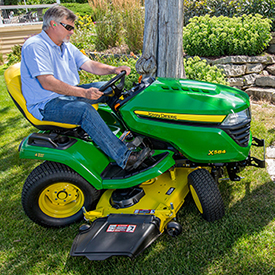 Four-wheel steer maneuverability
Four-wheel steer maneuverability
NOTE: In the schematic above, the solid line refers to a four-wheel steer tractor, and the hashed line refers to a two-wheel steer tractor.
Four-wheel steering provides very significant maneuverability and trimming advantages over two-wheel-steering equipped tractors (the following numbers correspond to the schematic above):
1. The uncut circle diameter is greatly reduced, eliminating or greatly reducing the need to back up when trimming around trees, shrubs, etc.
- Cutting inside turns created by landscaping, flower beds, etc. can also be done much more efficiently with a four-wheel-steer equipped tractor.
2. Interference from the mower and tractor wheels is eliminated because they are several inches away from the object being trimmed around.
- When cutting rectangle-shaped areas, square corners can be cut more effectively and efficiently.
3. The outside turning circle is reduced, reducing the time spent turning and increasing mowing efficiency.
Hydraulic power steering
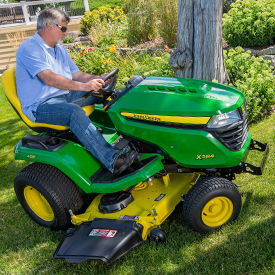 Power four-wheel steering
Power four-wheel steering

Hydraulic power steering is standard equipment to maximize the benefits of four-wheel steering with both tight turns and easy steering:
- Provides effortless automotive-like control
- Reduces operator fatigue and increases productivity
- Offers a tight turning radius for optimum maneuverability
- Very easy and efficient trimming around objects
Designed for tight turns
The four-wheel steering system is designed for tight turns, leading to greater mowing efficiency:
-
Caster, camber, and kingpin angles are optimized to reduce effort, especially when going from straight ahead to a turn.
-
Steering geometry has been designed with the use of 3-D modeling, so all four tires are working together.
-
Sealed ball bearings are used at the rear steering spindles to reduce friction.
-
Small scrub radius, less than 1 in. (2.54 cm) in the rear, reduces scuffing and bump-steer.
Hydrostatic transaxle has traction assist
 Hydrostatic transaxle
Hydrostatic transaxle
 Piston-type rotating groups
Piston-type rotating groups
The integrated hydrostatic transaxle (IHT) encloses the hydrostatic pump and motor rotating groups in the same housing with the differential and axle housing:
- Very efficient piston-type design
- Fewer sealing surfaces to minimize potential for leakage
When combined with the foot controls, the hydrostatic transmission functions similarly to that of an automatic transmission in an automobile, so the term automatic is often used to describe it.
Key features of the drive system are as follows:
- Large pump and motor rotating groups for long life and efficient operation
- Full-length axle housings to support heavy loads
- Twin Touch™ foot control for easy and precise change of speed and direction
- Internal wet-disk brakes for long life and consistent operation. Brake interlock system that returns the foot control pedals to neutral during panic stops.
- Return mechanism that closes the freewheeling valve when the brake pedal is depressed to start the engine
- Replaceable oil filter for extra protection for tractors equipped with hydraulic lift and steering
 Replaceable filter (X580, X584, X590)
Replaceable filter (X580, X584, X590)
Standard cruise control
 Cruise control
Cruise control
Cruise control is standard equipment:
- Maintains a set tractor ground speed for mowing large areas or when driving the tractor from one location to another.
- Convenient, easy-to-use button to activate cruise control function.
- Release cruise control with brake pedal or forward Twin Touch™ foot pedal
Traction assist (differential lock)
 Traction assist control
Traction assist control
Traction assist is standard equipment:
- Traction assist supplies positive power to both drive wheels for increased traction.
- Foot-operated traction assist control is convenient for the operator to use, when needed.
Lever-action or electric one-touch MulchControl™ options are available for extra mowing convenience
 Lever-action MulchContol lever
Lever-action MulchContol lever
 Electric one-touch MulchControl switch
Electric one-touch MulchControl switch
Lever-action or electric one-touch MulchControl attachment is available for Accel Deep™ 42-in. (107-cm) (42A), 48-in. (122-cm) (48A), and 54-in. (137-cm) (54A) Mower Decks used on X300 and X500 Select Series™ Tractors.
MulchControl advantages and benefits
MulchControl enhances versatility and productivity. A mower deck equipped with MulchControl not only does an excellent job of mowing and mulching, but it can also be quickly converted from side discharging to mulching or vice versa:
- In mulch mode, it controls clippings dispersion in unwanted areas (driveways, landscape beds, near buildings, windows, parking lots, etc.).
- Reduces cleanup time needed to dispose of clippings.
- Reduces the amount of material entering a material collection system because, even in the side discharge mode, MulchControl will mulch about one third of the material due to the additional baffles under the mower deck and the unique design of the mulching blades.
Electric MulchControl has the additional advantage of being controlled from the tractor seat by a switch on the dash to operate an electric actuator that moves the baffle to close off the discharge area of the mower deck.
 Electric one-touch MulchControl switch
Electric one-touch MulchControl switch
 Electric one-touch MulchControl actuator
Electric one-touch MulchControl actuator
- Operators can convert between modes without interrupting the mowing process, making it practical to change between modes as conditions require.
- When approaching clean areas like driveways or flowerbeds where clippings would be undesirable
- When a breeze might blow clippings back onto the operator
- For side discharge mowing only the areas of the property where grass is too thick for mulching
- With 48A and 54A Mower Decks, for collecting only the areas of the property where grass is too tall or thick for mulching
- With 48A and 54A Mower Decks, the MulchControl baffle can be opened or closed with the Power Flow™ blower installed. The Power Flow blower will run without material when the baffle is closed.
- Models equipped with a 42A Mower Deck require a MulchControl baffle be removed to install the bagger chute; see 42A Mower Deck versatility explanation for more information.
- Changing from one mode to the other takes only a few seconds.
How MulchControl works
A mower equipped with a MulchControl attachment delivers unprecedented levels of productivity and versatility. The operator has the ability to quickly change between side discharging and mulching. A heavy-duty baffle opens and closes to convert the mower from side discharge mode to mulch mode or vice versa.
 MulchControl baffle open (similar mower deck shown)
MulchControl baffle open (similar mower deck shown)
 MulchControl baffle closed (similar mower deck shown)
MulchControl baffle closed (similar mower deck shown)
MulchControl is an innovative, simple design that is easy to use and maintain:
- The MulchControl attachment includes baffles to control the flow of material under the deck.
- When the MulchControl baffle is open, most of the material flows freely out the discharge deflector or into a material collection system.
- When the MulchControl baffle is closed, material stays within the deck and gets chopped into mulch and deposited in the turf.
MulchControl is well-suited to the following mowing situations:
- For operators who usually mulch, but side discharge when grass gets too long
- For operators who usually side discharge, but would like to be able to close the chute to control clippings in some areas
- For operators who always mulch a main lawn, but often side discharge secondary lawns
- For operators who collect clippings, but want to go farther before emptying the material collection system
MulchControl puts the operator in control of the clippings. The operator can have all the benefits of mulching with the ability to easily change to side discharging when desired.
Advantages of MulchControl include:
- Performance is improved.
- Mulching is beneficial because it returns the clippings to the ground as fertilizer, which promotes lawn growth.
- Clippings are much smaller, which allows them to fall into the grass and be removed from view.
- Unsightly grass clippings are not blown onto driveways or into flower beds.
- Fertilizer use is reduced and provides associated environmental benefits.
- Uptime is increased.
- Operators can convert quickly between modes, making it possible to change between mulching and side discharging as conditions require.
- Mulching heavy, thick material can significantly reduce mower productivity. The ability to switch from mulch to side discharge mode ensures productivity, especially in grass too tall or thick to mulch effectively.
- Cost of operation is reduced.
- Controlling clipping dispersion reduces cleanup time.
MulchControl limitations
While in the side discharge mode, MulchControl will still mulch about one third of the material. Therefore, the side discharge mode is essentially a partial mulch mode. This can be an advantage when side discharging or bagging, as it helps to reduce the amount of material being discharged. Other times this could work as a disadvantage:
- When cutting strong southern grasses, such as Zoysia and Bermuda
- When cutting in wet, high growth conditions, such as those found in the Pacific Northwest United States
- When optimum bagging and lawn cleanup is desired
- 42A Mower Deck requires a MulchControl baffle be removed to install the bagger chute
Lever-action MulchControl attachments
| Attachment number | Description | Applications |
| BM24794 | 42A MulchControl (lever action) | X300 Series Tractors, Z300 Series ZTrak™ Mowers |
| BM24993 | 48A MulchControl (lever action) | X300 and X500 Series Tractors, Z300 and Z500 Series ZTrak Mowers |
| BM24994 | 54A MulchControl (lever action) | X300 and X500 Series Tractors, Z300 and Z500 Series ZTrak Mowers |
Electric one-touch MulchControl attachments
| Attachment number | Description | Applications |
| BUC10164 | 42A electric one-touch MulchControl | X300 Series Tractors* |
| BUC10165 | 48A electric one-touch MulchControl | X300 and X500 Series Tractors* |
| BUC10166 | 54A electric one-touch MulchControl | X300 and X500 Series Tractors* |
* NOTE: Model year 2016-2017 X300 and X500 Series Tractors (X300 serial number 10,001-50,000 and X500 serial number 110,001-130,000) require replacing the tractor wiring harness and dash panel to use an electric MulchControl attachment.
MulchControl compatibility
Each MulchControl attachment includes everything needed: baffles and mulch blades for all attachments, and the actuator, wiring, and switches for the electric one-touch attachments.
Snow removal and yard care is a strength of lawn tractors
 X590 Tractor shown with optional front blade and weather enclosure
X590 Tractor shown with optional front blade and weather enclosure
 X590 Tractor shown with optional snow blower and weather enclosure
X590 Tractor shown with optional snow blower and weather enclosure
An advantage of lawn tractors is their ability to use attachments for snow removal and other yard-care chores. Lawn tractor owners can add a John Deere snow blower or front blade to make quick work of moving snow whenever the need arises. Weather enclosure and tire-chain attachments add comfort and performance.
Equipment available for snow removal includes:
- 44-in. (112-cm) Snow Blower for X570 Tractor
- 47-in. (119-cm) Snow Blower for X580, X584, and X590 Tractors
- 48-in. (122-cm) Front Blade
- Tire chains or TerraGrip traction belts
- Weather enclosure
- Weights
 30-in. (76-cm) Mechanical Rotary Tiller
30-in. (76-cm) Mechanical Rotary Tiller
 42-in. (107-cm) Hydraulic Rotary Tiller
42-in. (107-cm) Hydraulic Rotary Tiller
Rotary tillers are real time savers for preparing seedbeds, controlling weeds, and other tillage jobs.
Equipment available for tilling includes:
- 30-in. (76-cm) Mechanical Rotary Tiller for X570, X580, and X590 Tractors
- 42-in. (107-cm) Hydraulic Rotary Tiller for X580 and X590 Tractors
- The hydraulic tiller is quieter operating and has the unique ability to operate with either forward or reverse tine rotation.
- Weights
Control and display functions are easy to identify and convenient to use
 Controls and gauges (steering wheel removed)
Controls and gauges (steering wheel removed)
 Dash (X590 Tractor shown with switch on to show display)
Dash (X590 Tractor shown with switch on to show display)
Controls
The contoured dash has clean, attractive styling and ergonomic controls for easy use:
- Controls are color-coded for easy identification by the operator.
- Controls are logically placed and easy to reach.
- The power take-off (PTO) switch allows the operator to get fingers underneath it, like a T-handle, to pull up for easy activation.
- The reverse implement option (RIO) switch is a yellow button.
- The latch control on foot-lift models and hydraulic-lift control on power-lift models and the park brake latch are pivot levers for low effort.
- Cruise control activation is handled by an automotive-style button.
- Separate engine speed and choke controls make starting and warming up the engine easier in cold weather.
- The choke lever is spring loaded to eliminate the chance the tractor will be unintentionally operated with the choke partially closed.
- Functional design of the throttle and choke controls provides good appearance and a comfortable feel.
Display panel
 Display panel
Display panel
 Display panel illustration with descriptions
Display panel illustration with descriptions
Instrument display has the look and feel of a modern automobile. A power-up sequence cycles lights and gauges to indicate they are working:
- Display features dark-cockpit design to minimize operator distractions.
- Display is back lit for night visibility.
- Night visibility is especially useful with snow blower use.
- Hour meter makes it easy to tell when oil changes and other maintenance should be performed.
- Electronic fuel gauge provides real-time fuel level information.
- A tachometer graphically displays engine speed.
- Target-zone graphics inform the operator of the engine speed range to use for best cut quality.
- An indicator tells the operator when the PTO is operating.
- Bright caution and stop lights capture the operator's attention when important information is on the instrument cluster.
- Damage can be prevented and repair costs reduced by addressing problems early.
- Operators are advised of what the problem is if they attempt to operate the mower with unsatisfied PTO, seat, or park brake interlocks.
- The indicators are also useful to identify the reasons the PTO or engine may have shut off when an interlock is unsatisfied.
- Operators are advised if battery voltage is low, normal, or excessive.
- The service indicator light illuminates to indicate a diagnostic error code is stored.
- On-board diagnostics provides trouble codes for use by trained technicians.
- For example, a technician will be able to test switch functionality and circuit continuity without tools.
- On-board diagnostics provides trouble codes for use by trained technicians.
Twin Touch™ foot control
 Twin Touch foot control
Twin Touch foot control
 Cruise control
Cruise control
Twin Touch foot pedals control the speed and direction of travel:
- Automotive-type accelerator control ensures easy operation.
- Operator can change direction without lifting foot off the platform.
- Large pedal surface gives superior operator comfort.
Cruise control
Cruise control is standard equipment:
- To engage, push the cruise-control button and hold until the foot is removed from the forward pedal.
- For emergency stop, the cruise control can be released by pushing on the brake pedal or the forward pedal.
Convenient hydraulic lift (X580, X584, X590)
 Hydraulic lift lever (X580, X584, X590)
Hydraulic lift lever (X580, X584, X590)
Convenient hydraulic lift lever makes raising and lowering the mower or implement easy:
- The hydraulic lift control lever is positioned on the dash near the steering wheel.
- Hydraulic lift provides quick, easy, and precise fingertip control of equipment.
- Implement float is built into the lift linkage.
Mower deck height adjustment
 Conveniently located mower deck height adjustment
Conveniently located mower deck height adjustment
 Onboard mower adjusting gauge and wrench
Onboard mower adjusting gauge and wrench
A rotary dial knob makes adjusting the mower cut height quick and easy:
- Mower cut height can be adjusted in 0.25-in. (6.4-mm) increments from 1 in. (2.5 cm) to 4 in. (10.2 cm).
- Mower deck returns to the same preset height each time it is lowered.
- Onboard deck-leveling gauge and Exact Adjust tool conveniently located in the storage compartment under the seat
- Used in conjunction with Exact Adjust ports for easy and accurate leveling of the mower deck for optimum mowing performance
 Deck-leveling gauge placed under deck
Deck-leveling gauge placed under deck
 Exact Adjust tool is used to level mower deck
Exact Adjust tool is used to level mower deck
Storage for the onboard deck-leveling gauge and the Exact Adjust tool is provided in the storage tray under the tractor’s seat:
- Exact Adjust ports allow for easy and accurate leveling of the mower deck for optimum mowing performance.
Deck-leveling gauge is placed at the appropriate location under the left rear, right rear, and front of the mower deck as the cut height is adjusted using the Exact Adjust tool and front draft arm adjusting nuts.
Foot pedal lift system (X570)
 Foot pedal lift system (X570)
Foot pedal lift system (X570)
 Foot-lift latch control
Foot-lift latch control
Pushing with the foot to raise the mower or implement is less strenuous for many operators:
- Easy-to-use raised-position lock operates similarly to the park brake lock.
- Foot pedal is out of the way and not likely to catch on bushes and tree limbs when mowing.
- Mower deck returns to the same preset height each time it is lowered.
 Lift-spring decals and bolt
Lift-spring decals and bolt
 Lift-assist spring decal
Lift-assist spring decal
A lift-assist spring is provided on the tractor to minimize lift effort:
-
Lift effort can be easily adjusted by just turning a bolt located on the tractor front bumper for optimum performance, depending on the equipment used (mower, front blade, etc.).
-
Decals on the outside of the tractor frame indicate appropriate adjustment.
-
The mower will not be inadvertently locked in the raised position when mowing through ditches.
-
When installing or removing a mower or front equipment raised by the foot-lift system, spring tension may be removed from the connection points.
-
Pull rearward on the lift pedal and raise the lift latch to hold the pedal in the rearward position.
-
Parking brake control
 Parking brake
Parking brake
Depressing the brake pedal applies force to internal wet-disk brake (which provides excellent durability and long life) for safe stopping.
Parking brake control is conveniently located for easy access; holds brake pedal securely in locked position.
Electric power take-off (PTO) clutch is easy and convenient to use
 Electric PTO switch
Electric PTO switch
The heavy-duty electric PTO clutch is operated with a convenient dash-mounted switch.
Heavy-duty PTO clutch
 PTO clutch
PTO clutch
The PTO clutch is designed to operate through many on/off cycles.
RIO
 Reverse implement switch
Reverse implement switch
Using RIO
CAUTION: Children or bystanders may be injured by rotating blades. Before traveling forward or rearward:
- Carefully check the area around the machine.
- Disengage the mower before backing up.
NOTE: Operating the mower while backing up is strongly discouraged. RIO should be used only when operating another attachment or when the operator deems it necessary to reposition the machine with the mower engaged.
- Stop forward travel. Allow attachment to run.
- Look down and behind the machine to be sure that there are no bystanders.
- Push and hold in the reverse implement switch while depressing the reverse pedal slightly.
NOTE: If the attachment stops while positioning the machine, return mower engagement (PTO) switch to off position. Repeat this procedure from the beginning. - Release the reverse implement switch and reposition the machine as the machine begins to move rearward.
- Resume forward travel. The attachment should continue operating.
- Repeat procedure to position the machine again.
Frame is formed from thick steel and welded for reliability
 Heavy-duty welded frame
Heavy-duty welded frame
 Front bumper/weight bracket
Front bumper/weight bracket
The frame is made of heavy-duty formed and welded steel, reinforced in critical areas for even greater strength:
- Frame is formed from 12-gauge, 0.105-in. (2.66-mm) thick material.
- Front bumper and hitch plate are formed from 0.25-in. (6.4-mm) steel and complete the frame assembly.
- Front bumper can support up to four 42-lb (19-kg) Quik-Tatch weights.
- Rear hitch plate can support up to four 42-lb (19-kg) Quik-Tatch weights.
- X584 requires an optional rear weight bracket.
Optional Quik-Tatch weights
 Shown with four optional 42-lb (19-kg) Quik-Tatch weights
Shown with four optional 42-lb (19-kg) Quik-Tatch weights
The front bumper holds up to four 42-lb (19-kg) Quik-Tatch weights.
Front axle and wheel spindles are heavy duty
 Cast-iron front axle
Cast-iron front axle
The front axle is made of nodular cast iron:
- Strong and shock resistant
- Will not yield under heavy loads or impact
Replaceable bushings are used at the center axle pivot and steering spindles:
- Provide excellent wear resistance
- Grease cavity between bushings maintains lubrication and easy steering between greasings
- Easy-to-service grease fittings at each spindle
Front steering spindles
 Steering spindle (X570 shown)
Steering spindle (X570 shown)
The front steering spindles are strong for long life:
- Have the strength to handle heavy implements
- 0.75-in. (19-mm) steering spindle diameter (X570)
- 1-in. (25.4-mm) steering spindle diameter (X580, X584, X590)
- Provide long life at bearing surfaces
- 0.75-in. (19-mm) diameter front wheel bearings (X570)
- 1-in. (25.4-mm) diameter front wheel bearings (X580, X584, X590)
- Sealed precision ball bearings at front wheels ensure long life and are maintenance free
Rear equipment-mounting system is heavy-duty and easy to use
 Rear equipment mounting system
Rear equipment mounting system
A heavy-duty equipment mounting system is used:
- Includes strong frame mounts with a combination of mounting holes in the tractor hitch plate that accept pins or shoulder bolts to support heavy rear-mounted equipment.
- Easily attach optional equipment to the tractor
- Can bear the load of heavy rear-mounted equipment, such as material collection systems
Modern styling is eye appealing and functional
 Attractive styling
Attractive styling
 Side-hood vents
Side-hood vents
Smooth, rounded contours present a modern, styled appearance:
- Hood styling incorporates efficient full-length air-intake louvers on each side.
- Cooler engine operation
- Lower operator station sound levels
- Hot air is vented out the front grill, away from the operator.
- The fully enclosed hood is made of molded-in-color material.
- Reduces sound
- Will not rust or dent
- Distinctive grille and large, one-piece fender deck complete the styling package.
Versatility and premium features for great performance with larger equipment
 X590 show with 47-in. (119-cm) Snow Blower
X590 show with 47-in. (119-cm) Snow Blower
 X590 Tractor shown
X590 Tractor shown
Premium features ensure the versatility of X500 Series Tractors:
- Heavy-duty welded-steel frame with integrated rear weight bracket
- Integrated front weight bracket (X580, X584, X590)
- Air-cooled John Deere iTorque™ power system
- Differential lock
- Convenient foot-pedal lift system (X570) or easy-to-use hydraulic lift (X580, X584, X590)
- Low-effort manual steering (X570) or power steering (X580, X584, X590)
- Five-position tilt steering wheel (X584, X590)
- Heavy-duty all-purpose (HDAP) rear tires (X580, X590)
- Accel Deep™ Mower Decks with optional MulchControl™ system
Two headlights give excellent visibility
 Quality headlights
Quality headlights
Headlights are standard equipment.
High-quality headlights make evening work easier and safer:
- Two 27-W bulbs provide excellent lighting for improved visibility during evening operation.
- A headlight position on the ignition switch makes it easy to operate the headlights.
- Headlights are designed to provide an optimum lighting pattern for mowing and snow removal.
Operator station is comfortable and convenient
 Dash controls are color coded for identification
Dash controls are color coded for identification
 Automotive-like dash display
Automotive-like dash display
The operator station is designed for operator comfort and convenience in operating all controls. The controls are easy to use and color coded for quick identification.
Comfortable seats
 15-in. (38-cm) open-back seat (X570, X580)
15-in. (38-cm) open-back seat (X570, X580)
 21-in. (53-cm) high-back seat (X584, X590)
21-in. (53-cm) high-back seat (X584, X590)
The 15-in. (38-cm) open-back seat (X570, X580) features distinctive styling and is designed for comfort:
- Open-back design allows air circulation to keep the operator's back cool and dry for a more comfortable ride.
- Hand grip at the top of the seat is conveniently located for use when tilting the seat up to protect it from the weather.
The 21-in. (53-cm) high-back seat (X584, X590) provides additional comfort and support for the operator.
Adjustable suspension
 Seat shown with optional storage pocket
Seat shown with optional storage pocket
The seat suspension is easily adjusted to make most any operator comfortable:
- 7 in. (18 cm) of seat travel allows the operator to be seated comfortably and operate the controls easily.
- Seat can be easily adjusted fore and aft by the operator while sitting on the seat (15 positions).
- Seat features a suspension that is easily adjusted for the operator's weight and height.
- Springs provide a smooth ride and will not bottom out.
- Spring position is adjustable for the operator's weight.
- Seat tilts forward to keep the seating surface out of the weather.
- Tilting the seat forward keeps moisture and the sun off the seat cushion for greater operator comfort.
- Optional storage pocket (X570, X580) provides a convenient storage area for gloves, etc.
Optional 21-in. (53.3-cm) professional two-piece seat, four-bar suspension, and slide
 Seat has convenient tilt-back feature
Seat has convenient tilt-back feature
 Tilt-back seat control
Tilt-back seat control
The optional 21-in. (53.3-cm) professional two-piece seat, four-bar suspension, and slide shipped on Signature Series X700 Tractors is available as an upgrade seat and suspension for all X500 Multi-Terrain Tractors (model year 2006-). Key selling features for this seat include:
- Thick seat cushion for lasting comfort, even after a full day of use
- Back of seat can be angled to maximize operator comfort
- Convenient lever on the side of the seat unlocks back of seat to allow positioning
- Four-bar suspension and slide are included for extra comfort and bolt to the tractors fender-deck mounting holes
- BM24426 armrest attachment available as a field-installed option
Optional armrest attachment
 Adjustable armrest option
Adjustable armrest option
 Left armrest in raised position
Left armrest in raised position
Armrests increase operator support and comfort, thus reducing fatigue and improving productivity, especially when mowing for extended periods of time. Armrests are adjustable to suit the operator. This armrest attachment is designed for the optional 21-in. (53.3-cm) professional two-piece seat.
Tilt steering wheel (X584, X590)
 Tilt steering wheel (lowest position)
Tilt steering wheel (lowest position)
 Tilt steering wheel (highest position)
Tilt steering wheel (highest position)
- Five steering-wheel positions allow the operator to select the most comfortable setting (X584, X590).
Rubber foot pads
 Rubber foot pads
Rubber foot pads
Rubber foot pads make the operator more comfortable:
- Help insulate operator's feet from vibration
- Attractive styling
- Long-lasting wear surface
- Reduce chance of slippage, even with wet surface
 Cup holder, toolbox, and fender handle
Cup holder, toolbox, and fender handle
A cup holder and covered toolbox are conveniently located on the fender next to the operator's seat.
Handles on each fender are useful when getting on and off the tractor.
 Standard 12-V outlet
Standard 12-V outlet
A 12-V outlet is standard equipment and provides a convenient plug-in for electrical equipment.
 Illustration of fast connector location
Illustration of fast connector location
A mid-vehicle 12-V fast connector, located under the tractor’s fuse box, is included as standard equipment to reduce initial installation time for some attachments that operate on 12-V power from the tractor:
- The four-cavity connector includes battery, ground, and key switch terminals and is turned on and off with the ignition switch.
Serviceability is convenient with easy-open hood
 One-piece hood is easy to open
One-piece hood is easy to open
 Service interval decal located under hood
Service interval decal located under hood
The one-piece hood opens easily to permit checking and servicing the engine:
- Important service points are located within easy reach.
- A service-interval decal is provided inside the tractor hood for convenience when servicing the tractor.
- The high-quality engine used in the X500 Series does not require an 8-hour oil and filter change because improvements in manufacturing processes and quality of parts, components, and oils have eliminated the need for the short interval oil change requirement.
 Easy-to-service engine fuel and oil filters
Easy-to-service engine fuel and oil filters
The engine fuel and oil filters, the oil check/fill tube, and the oil drain tube are exposed for serviceability when the hood is opened.
Exact Adjust ports and onboard deck-leveling tools make precise deck adjustments easy
 Deck-leveling gauge and hex adjusting tool stored under tractor seat
Deck-leveling gauge and hex adjusting tool stored under tractor seat
 Exact Adjust access holes
Exact Adjust access holes
A mower deck must be level side-to-side and properly adjusted front-to-rear to give the best cutting performance. A removable onboard deck-leveling gauge and a hex-key tool are provided to make adjustment easy. They are securely stored under the tractor seat.
Exact Adjust leveling ports are provided on each side of the operator platform above the mower-level adjusting bolts. With the hex-shaped tool, they provide convenient access to allow quick and easy adjustment of the mower for the best-cut quality of cut.
The Exact Adjust feature is standard on all Select Series™ X300 and X500 Tractors:
- There is no need to reach under the fender deck while making the mower-level adjustment.
- Onboard deck-leveling gauge, Exact Adjust ports, and the hex tool work together.
- Level the mower deck side to side
- Set the correct amount of rake (front-to-back deck orientation)
- Calibrate the cutting height to the cut-height adjusting knob setting
- Exact Adjust simplifies leveling the mower deck if equipped with a Power Flow™ blower.
- To give the best cut, mower level should be adjusted if alternately mowing with and without blower installed. The Exact Adjust feature makes this easy.
 Deck-leveling tool placed under deck
Deck-leveling tool placed under deck
 Using included ball-hex tool to level mower deck
Using included ball-hex tool to level mower deck
Consult the operator's manual for the correct adjusting procedures for each tractor model. Basic adjusting steps to properly level the mower deck include:
- Park the tractor on a level surface.
- Inflate tires to the correct pressure.
- Consult the label for the cutting-height knob that is located on the console of the machine. This label shows deck-leveling position and location of deck-leveling adjustment points.
 Cut height adjusting knob
Cut height adjusting knob
- Set mower cutting-height knob to the correct deck-leveling position.
- For X300 models, use position 2.75
- For all other models, use position 2.5
- Adjust mower wheels as necessary so they do not contact the ground surface.
- Remove the onboard deck-leveling gauge that is located under the seat.
- Using the Exact Adjust ports and tool, adjust mower deck side-to-side level so the deck-leveling gauge just slips under the left and right lower deck rim at the designated adjustment points. The location of adjustment points will vary slightly between decks.
- Left- and right-rear adjustment points are under the deck rim near the rear mower wheels, if equipped.
- Adjust mower deck front-to-back level, if necessary.
- Loosen rear nuts equally on each side of front lift rod.
- Turn front nut equally on each side clockwise to raise front of mower or counterclockwise to lower it until gauge just slips under the front adjustment point.
- Tighten rear nuts after adjustment is complete.
- Return the gauge to its storage position.
NOTE: The adjusting tool supplied with the tractor is an 8-mm ball-hex key, part number M162737. The rounded end allows for some misalignment with the bolt as the deck is adjusted.
The MowerPlus™ app helps maintain the tractor and lawn
 MowerPlus app screen
MowerPlus app screen
 MowerPlus app maintenance screen
MowerPlus app maintenance screen
Keep a John Deere riding lawn mower running its best and know how it mows with the John Deere MowerPlus app. Simply scan the lawn tractor’s barcode to get custom information. The app helps determine the best time to mow, communicates expert pre-mow tips, offers maintenance reminders, and provides walk-through guides.
Look for the MowerPlus app on the mobile device’s app store.
The app supports residential lawn equipment such as 100 Series, S240, X300, X500, X700, Z200 through Z600, and many similarly-sized older products. It does not presently support tractor models numbered 1000 and larger, such as 1025R.
NOTE: Some product image variation may exist.
Also available is the John Deere MowerPlus smart connector (sold separately).
 Smart connector
Smart connector
The John Deere MowerPlus smart connector wirelessly links a Select Series™ X300 or X500 Tractor to the MowerPlus app on a mobile device. The smart connector transmits engine usage to the app, making it easy to track maintenance intervals. It also transmits the fuel level to the app—when thinking ahead about Saturday morning mowing, the operator can make sure the tractor is fueled and ready to go.
Features
Engine is smooth running and reliable V-twin air-cooled design
 Smooth-running V-twin engine
Smooth-running V-twin engine

The tractor is powered by a John Deere iTorque™ power system, a combination of engine features and an exclusive hood design providing superior lugging ability, even cooling, and durability. Key engine features include:
- 24 hp (17.9 kW)
- Large 726 cc displacement
- V-twin air-cooled design
- Excellent power and performance
- Smooth, quiet power
- Easy starts
- Quality features include:
- Cast-iron cylinder liners
- Overhead valves
- Full-pressure lubrication
- Replaceable oil filter
- Dual-stage air cleaner
- Solenoid-shift starter for easy starts, even in cold weather
Flywheel alternator
A flywheel alternator provides plenty of capacity to quickly recharge the battery and power electrical equipment, such as lights or a sprayer:
- 15-amp capacity
- Regulated to keep the battery at a full charge, without risk of overcharging
Fuel tank has a large, 4.4-U.S. gal. (16.6-L) capacity
 Fuel tank
Fuel tank
Quality fuel system components enhance performance and convenience:
- Large, 4.4-U.S. gal. (16.6-L) capacity
- Wide, 3-in. (7.6-cm) diameter fuel tank filler opening
- Located on the left fender
- Makes adding fuel easy and helps eliminate spillage
- Sealed and tethered fuel cap
- Reduced fuel vapor loss
- Less chance of losing fuel cap
 Convenient dash-mounted fuel gauge
Convenient dash-mounted fuel gauge
- Automotive-style fuel gauge on the dash
- Easy to read from tractor seat
- Reduces likelihood of running out of fuel
- Eliminates unnecessary stops to refill
The 54-in. (137-cm) Accel Deep™ (54A) Mower Deck cuts clean and is versatile
 X394 with Accel Deep 54A Mower
X394 with Accel Deep 54A Mower
 Accel Deep 54A Mower
Accel Deep 54A Mower
The 54-in. (137-cm) Accel Deep Deck uses the latest in three-spindle mowing technology to raise performance to a higher level:
- 10-gauge, 0.135-in. (3.4-mm) deck stamping for long life
- Deep, flat-top deck design to handle a large volume of material at faster mowing speeds
- Gives excellent cut quality and uniform discharge
- Easy to keep clean on top of and under the deck
- Resilient four-point mounting system suspends mower from tractor for a smooth and level cut
- Wide mower wheels easily adjusted just above ground level to help prevent scalping
- 0.25-in. (6.4-mm) cut-height increments allow mower to be set at the desired cut height
- Onboard deck-leveling system makes keeping mower properly adjusted easy
- Compatible with optional MulchControl™ mulching system
- Compatible with high-performance Power Flow™ material collection systems
- For use on X380, X384, X390, X394, X570, X580, X584, and model year 2016 X590 Tractors
The 54-in. (137-cm) Accel Deep Mower Deck is a stamped-steel, deep, flat-top design that delivers excellent cut quality, productivity, cleanliness, durability, and versatility. Optimal performance and dispersion of clippings is provided, even at faster mowing speeds:
- 4.83-in. (12.3-cm) depth throughout the entire deck shell for optimum mowing, mulching, and bagging performance
- Optional lever-action or electric one-touch MulchControl attachment provides superior mulching performance and versatility.
- Stamped-steel design eliminates sharp edges and corners where material can build up and diminish mowing performance
- Mower deck is suspended from the vehicle for a smooth and level cut
- Adjustable mower wheels, positioned just above ground level, help reduce scalping
Excellent cut quality
 54A Mower top
54A Mower top
 54A Mower underside
54A Mower underside
Deep mower-deck stamping gives excellent cut quality. It allows the cut and suspended material room to exit the deck without getting recut:
- Reducing the amount of re-cutting enables more power to be used to cut incoming grass, which greatly improves mower capacity.
- Helps maintain excellent cut quality at faster mowing speeds
- Clean flow of material out of discharge area prevents cut material from interfering with cutting the incoming grass, making it possible for the blades to cut incoming material cleanly.
- Even in mulching mode, cut evenness is improved compared to other designs because the additional depth allows for continuous circulation, optimal re-cutting, and an even distribution of clippings.
Productivity - getting the job done fast
 Right side of Accel Deep 54A Mower Deck
Right side of Accel Deep 54A Mower Deck
Deep mower-deck stamping gives high productivity, which gets the job done fast. It allows the cut and suspended material room to exit the deck quickly, reducing the amount of re-cutting so more power is available to process incoming grass:
- Greatly improves mowers capacity to maintain excellent mowing performance in difficult mowing conditions and at higher speeds
Large discharge opening is both high and wide to handle more material:
- Gives a smooth, even discharge of clippings at all mowing speeds
- Reduces the chance of plugging, especially important when operating in wet, thick, or dense grass and when bagging
- The 54A Power Flow blower has an inlet housing with over 20 percent greater area than the 54X Power Flow blower used on previous machines.
Cleanliness - for the mower and the operator
 Accel Deep 54A Mower Deck
Accel Deep 54A Mower Deck
 Accel Deep 54A Mower Deck
Accel Deep 54A Mower Deck
The flat-top shape of the deck stamping is optimal for keeping itself and the operator clean:
- There are few places to catch and hold material on top and underneath the deck.
- Top of deck stays cleaner, reducing time and effort needed for cleaning and service
- Underside of deck is self-cleaning to maintain optimum performance without build-up of material to interfere with the flow of air and clippings
- Less need to clean and remove build-up of material from underside deck
- The depth of the Accel Deep mower deck minimizes the amount of material that escapes from the front of the deck:
- Limited amount of material to drift onto the operator and mower deck
- Even for material discharged out the chute, less re-cutting results in larger pieces that are less likely to end up on the operator
- Mulching prevents the discharge of material completely and a MulchControl attachment makes mulching a practical solution for most mowing situations.
Cleaning a mower deck, both top and bottom, is one of the most frequent maintenance activities:
- The flat-top design reduces places for material to build up and makes material that does collect easy to remove.
 Mower wash port
Mower wash port
 Mower wash port with hose connector
Mower wash port with hose connector
A wash port is provided to make cleaning the underside of the mower deck easy.
- Hose connector is included with the mower deck.
How MulchControl works
 MulchControl baffle open
MulchControl baffle open
 MulchControl baffle closed
MulchControl baffle closed
MulchControl is an innovative, simple design that is easy to use and maintain:
- The MulchControl attachment includes baffles to control the flow of material under the deck.
- The MulchControl baffle, or divider, between the left and middle spindles is about half way down. The height is designed to balance the mulch and side-discharge modes.
- When the MulchControl baffle is open, the divider between the left and middle spindles passes a portion of the material to the discharge opening, along with the material from the middle and right spindle areas.
- When the MulchControl baffle is closed, the material stays within the deck and gets chopped into mulch and deposited in the turf.
Superior durability is designed in
 Spindle pocket with flip-up cover
Spindle pocket with flip-up cover
 Easy-to-adjust mower wheel and mower side reinforcement
Easy-to-adjust mower wheel and mower side reinforcement
The 54A Mower Deck has strong spindle pockets, to keep the blades aligned, even after years of tough service:
- Ribs in the deck shell add strength where it is needed.
- The 54A has a 3 percent heavier overall weight than the Edge™ Xtra 54-in. (137-cm) mower deck used on previous machines.
Mower wheels are heavy duty:
- Provides greater strength and durability for longer, trouble-free life.
- Setting wheels to the correct height for the cutting height quick and easy.
Low-tension belt-drive design reduces the side load on engine lower bearings and mower deck bearings for longer life.
The 54A Mower Deck features a 5/8-in. (16-mm) diameter solid-steel rod side bumper that provides extra strength and protection.
Dual-stage E-coat and powder-paint coatings provide extra protection from rust.
Versatility - easy to change between side discharge, mulch, and bagging modes
The 54A Mower is designed for maximum versatility, providing the greatest ease in changing from one mower discharge mode to another:
- With an optional MulchControl attachment installed (along with the special mulching blades), changing from mulch mode to side discharge mode or vice versa is done with the simple flip of a lever or touch of an electric switch.
- The Power Flow rear bagger can be used with the MulchControl attachment and blades installed by simply using the MulchControl lever or electric one-touch switch to move the MulchControl baffle to the side-discharge position.
MulchControl option
A MulchControl attachment for the 54A Mower Deck makes mulching more practical for many mowing situations because it not only does an excellent job of mulching but it also allows the mower to be easily converted for times when it is more desirable to side discharge or collect the lawn material. Advantages of mulching grass clippings include:
- A beautiful looking lawn
- Grass clippings not blown onto the operator, driveways, or flower beds
- Less fertilizer use
- Elimination of the effort needed to dispose of clippings
 MulchControl handle
MulchControl handle
 Electric one-touch MulchControl switch
Electric one-touch MulchControl switch
- For the lever-action MulchControl attachment, the MulchControl lever on top of the mower deck is used to engage or disengage mulch mode.
- The operator is required to get off of the tractor in order to engage or disengage mulch mode with the lever-action system.
- For the electric one-touch MulchControl attachment, the electric switch on the tractor dash is used to engage or disengage mulch mode.
- Changing from mulch mode to side discharge mode or vice versa takes only a few seconds.
MulchControl is well-suited to the following mowing situations:
- Usually mulch, but side discharge when grass gets too long
- Usually side-discharge, but would like to be able to close the chute to control clippings
- Always mulch a main lawn, but often side discharge secondary lawns
- Bag clippings, but want to go farther before emptying bags
MulchControl puts the operator in control of the clippings. The operator can have all the benefits of mulching with the ability to easily change to side discharging or bagging when needed.
While in the side-discharge mode, MulchControl will still mulch about one third of the material. Therefore, the side-discharge mode is essentially a partial-mulch mode. This can be an advantage when side discharging or bagging, as it helps to reduce the amount of material being discharged. Other times this could work as a disadvantage:
- When cutting strong southern grasses, such as Zoysia and Bermuda
- When cutting in wet, high-growth conditions, such as those found in the Pacific Northwest United States
- When optimum bagging and lawn clean-up is desired
7-bu (247-L) Power Flow rear bagger
 Optional 7-bu (247-L) rear bagger
Optional 7-bu (247-L) rear bagger
 Power Flow blower
Power Flow blower
An optional 7-bu (247-L) rear bagger material collection system (MCS) is available. It provides an efficient means of collecting grass clippings and leaves:
- The Power Flow blower and chute are easy to install. The Power Flow blower swings out for easy cleanout and cleanup.
- The hopper design provides modern styling, great bagging performance, cleaner operation, and easy-to-empty bags:
- 7-bu (247-L) capacity
- Easy-to-attach Power Flow blower (ordered separately)
- Easy-to-attach chute (ordered separately)
- Air exhaust duct
- Convenient spring-latch
- Airflow fill indicator
- Quik-Tatch mounting
- Sealed hopper top
- Loose-knit bags available
Larger 14-bu (493-L) and 19-bu (670-L) MCS are available, in addition to the 7-bu (247-L) MCS, for specific X300 and X500 Series Tractor models.
Four-year or 500-hour bumper-to-bumper warranty is standard
An exclusive 4-year or 500-hour (whichever comes first), single-source, bumper-to-bumper warranty* is standard for all John Deere X500 Series Tractors.
- The warranty is hassle free, with one company handling all of the paperwork.
- Premium features of X500 Series Tractors allow for this longer warranty period, with more coverage than comparable tractors.
*Term limited to years or hours used, whichever comes first, and varies by model. See the LIMITED WARRANTY FOR NEW JOHN DEERE TURF AND UTILITY EQUIPMENT at JohnDeere.com or JohnDeere.ca/TUWarranty for details.
Power steering and hydraulic lift enable easy operation
 Power steering cylinder
Power steering cylinder
 Tilt steering wheel control lever
Tilt steering wheel control lever
Hydraulic power steering is standard equipment:
- Provides effortless automotive-like control
- Reduces operator fatigue and increases productivity
- Offers a tight turning radius for great maneuverability
- Adjustable-tilt steering wheel for optimum operator comfort (X584 and X590)
Convenient hydraulic lift
 Hydraulic lift lever
Hydraulic lift lever
Convenient hydraulic lift lever makes raising and lowering the mower or implement easy:
- The hydraulic lift control lever is positioned on the dash near the steering wheel.
- Hydraulic lift provides quick, easy, and precise fingertip control of equipment.
- Implement float is built into the lift linkage.
Hydrostatic transaxle has traction assist
 Hydrostatic transaxle
Hydrostatic transaxle
 Piston-type rotating groups
Piston-type rotating groups
The integrated hydrostatic transaxle (IHT) encloses the hydrostatic pump and motor rotating groups in the same housing with the differential and axle housing:
- Very efficient piston-type design
- Fewer sealing surfaces to minimize potential for leakage
When combined with the foot controls, the hydrostatic transmission functions similarly to that of an automatic transmission in an automobile, so the term automatic is often used to describe it.
Key features of the drive system are as follows:
- Large pump and motor rotating groups for long life and efficient operation
- Full-length axle housings to support heavy loads
- Twin Touch™ foot control for easy and precise change of speed and direction
- Internal wet-disk brakes for long life and consistent operation. Brake interlock system that returns the foot control pedals to neutral during panic stops.
- Return mechanism that closes the freewheeling valve when the brake pedal is depressed to start the engine
- Replaceable oil filter for extra protection for tractors equipped with hydraulic lift and steering
 Replaceable filter (X580, X584, X590)
Replaceable filter (X580, X584, X590)
Standard cruise control
 Cruise control
Cruise control
Cruise control is standard equipment:
- Maintains a set tractor ground speed for mowing large areas or when driving the tractor from one location to another.
- Convenient, easy-to-use button to activate cruise control function.
- Release cruise control with brake pedal or forward Twin Touch™ foot pedal
Traction assist (differential lock)
 Traction assist control
Traction assist control
Traction assist is standard equipment:
- Traction assist supplies positive power to both drive wheels for increased traction.
- Foot-operated traction assist control is convenient for the operator to use, when needed.
Lever-action or electric one-touch MulchControl™ options are available for extra mowing convenience
 Lever-action MulchContol lever
Lever-action MulchContol lever
 Electric one-touch MulchControl switch
Electric one-touch MulchControl switch
Lever-action or electric one-touch MulchControl attachment is available for Accel Deep™ 42-in. (107-cm) (42A), 48-in. (122-cm) (48A), and 54-in. (137-cm) (54A) Mower Decks used on X300 and X500 Select Series™ Tractors.
MulchControl advantages and benefits
MulchControl enhances versatility and productivity. A mower deck equipped with MulchControl not only does an excellent job of mowing and mulching, but it can also be quickly converted from side discharging to mulching or vice versa:
- In mulch mode, it controls clippings dispersion in unwanted areas (driveways, landscape beds, near buildings, windows, parking lots, etc.).
- Reduces cleanup time needed to dispose of clippings.
- Reduces the amount of material entering a material collection system because, even in the side discharge mode, MulchControl will mulch about one third of the material due to the additional baffles under the mower deck and the unique design of the mulching blades.
Electric MulchControl has the additional advantage of being controlled from the tractor seat by a switch on the dash to operate an electric actuator that moves the baffle to close off the discharge area of the mower deck.
 Electric one-touch MulchControl switch
Electric one-touch MulchControl switch
 Electric one-touch MulchControl actuator
Electric one-touch MulchControl actuator
- Operators can convert between modes without interrupting the mowing process, making it practical to change between modes as conditions require.
- When approaching clean areas like driveways or flowerbeds where clippings would be undesirable
- When a breeze might blow clippings back onto the operator
- For side discharge mowing only the areas of the property where grass is too thick for mulching
- With 48A and 54A Mower Decks, for collecting only the areas of the property where grass is too tall or thick for mulching
- With 48A and 54A Mower Decks, the MulchControl baffle can be opened or closed with the Power Flow™ blower installed. The Power Flow blower will run without material when the baffle is closed.
- Models equipped with a 42A Mower Deck require a MulchControl baffle be removed to install the bagger chute; see 42A Mower Deck versatility explanation for more information.
- Changing from one mode to the other takes only a few seconds.
How MulchControl works
A mower equipped with a MulchControl attachment delivers unprecedented levels of productivity and versatility. The operator has the ability to quickly change between side discharging and mulching. A heavy-duty baffle opens and closes to convert the mower from side discharge mode to mulch mode or vice versa.
 MulchControl baffle open (similar mower deck shown)
MulchControl baffle open (similar mower deck shown)
 MulchControl baffle closed (similar mower deck shown)
MulchControl baffle closed (similar mower deck shown)
MulchControl is an innovative, simple design that is easy to use and maintain:
- The MulchControl attachment includes baffles to control the flow of material under the deck.
- When the MulchControl baffle is open, most of the material flows freely out the discharge deflector or into a material collection system.
- When the MulchControl baffle is closed, material stays within the deck and gets chopped into mulch and deposited in the turf.
MulchControl is well-suited to the following mowing situations:
- For operators who usually mulch, but side discharge when grass gets too long
- For operators who usually side discharge, but would like to be able to close the chute to control clippings in some areas
- For operators who always mulch a main lawn, but often side discharge secondary lawns
- For operators who collect clippings, but want to go farther before emptying the material collection system
MulchControl puts the operator in control of the clippings. The operator can have all the benefits of mulching with the ability to easily change to side discharging when desired.
Advantages of MulchControl include:
- Performance is improved.
- Mulching is beneficial because it returns the clippings to the ground as fertilizer, which promotes lawn growth.
- Clippings are much smaller, which allows them to fall into the grass and be removed from view.
- Unsightly grass clippings are not blown onto driveways or into flower beds.
- Fertilizer use is reduced and provides associated environmental benefits.
- Uptime is increased.
- Operators can convert quickly between modes, making it possible to change between mulching and side discharging as conditions require.
- Mulching heavy, thick material can significantly reduce mower productivity. The ability to switch from mulch to side discharge mode ensures productivity, especially in grass too tall or thick to mulch effectively.
- Cost of operation is reduced.
- Controlling clipping dispersion reduces cleanup time.
MulchControl limitations
While in the side discharge mode, MulchControl will still mulch about one third of the material. Therefore, the side discharge mode is essentially a partial mulch mode. This can be an advantage when side discharging or bagging, as it helps to reduce the amount of material being discharged. Other times this could work as a disadvantage:
- When cutting strong southern grasses, such as Zoysia and Bermuda
- When cutting in wet, high growth conditions, such as those found in the Pacific Northwest United States
- When optimum bagging and lawn cleanup is desired
- 42A Mower Deck requires a MulchControl baffle be removed to install the bagger chute
Lever-action MulchControl attachments
| Attachment number | Description | Applications |
| BM24794 | 42A MulchControl (lever action) | X300 Series Tractors, Z300 Series ZTrak™ Mowers |
| BM24993 | 48A MulchControl (lever action) | X300 and X500 Series Tractors, Z300 and Z500 Series ZTrak Mowers |
| BM24994 | 54A MulchControl (lever action) | X300 and X500 Series Tractors, Z300 and Z500 Series ZTrak Mowers |
Electric one-touch MulchControl attachments
| Attachment number | Description | Applications |
| BUC10164 | 42A electric one-touch MulchControl | X300 Series Tractors* |
| BUC10165 | 48A electric one-touch MulchControl | X300 and X500 Series Tractors* |
| BUC10166 | 54A electric one-touch MulchControl | X300 and X500 Series Tractors* |
* NOTE: Model year 2016-2017 X300 and X500 Series Tractors (X300 serial number 10,001-50,000 and X500 serial number 110,001-130,000) require replacing the tractor wiring harness and dash panel to use an electric MulchControl attachment.
MulchControl compatibility
Each MulchControl attachment includes everything needed: baffles and mulch blades for all attachments, and the actuator, wiring, and switches for the electric one-touch attachments.
Snow removal and yard care is a strength of lawn tractors
 X590 Tractor shown with optional front blade and weather enclosure
X590 Tractor shown with optional front blade and weather enclosure
 X590 Tractor shown with optional snow blower and weather enclosure
X590 Tractor shown with optional snow blower and weather enclosure
An advantage of lawn tractors is their ability to use attachments for snow removal and other yard-care chores. Lawn tractor owners can add a John Deere snow blower or front blade to make quick work of moving snow whenever the need arises. Weather enclosure and tire-chain attachments add comfort and performance.
Equipment available for snow removal includes:
- 44-in. (112-cm) Snow Blower for X570 Tractor
- 47-in. (119-cm) Snow Blower for X580, X584, and X590 Tractors
- 48-in. (122-cm) Front Blade
- Tire chains or TerraGrip traction belts
- Weather enclosure
- Weights
 30-in. (76-cm) Mechanical Rotary Tiller
30-in. (76-cm) Mechanical Rotary Tiller
 42-in. (107-cm) Hydraulic Rotary Tiller
42-in. (107-cm) Hydraulic Rotary Tiller
Rotary tillers are real time savers for preparing seedbeds, controlling weeds, and other tillage jobs.
Equipment available for tilling includes:
- 30-in. (76-cm) Mechanical Rotary Tiller for X570, X580, and X590 Tractors
- 42-in. (107-cm) Hydraulic Rotary Tiller for X580 and X590 Tractors
- The hydraulic tiller is quieter operating and has the unique ability to operate with either forward or reverse tine rotation.
- Weights
Control and display functions are easy to identify and convenient to use
 Controls and gauges (steering wheel removed)
Controls and gauges (steering wheel removed)
 Dash (X590 Tractor shown with switch on to show display)
Dash (X590 Tractor shown with switch on to show display)
Controls
The contoured dash has clean, attractive styling and ergonomic controls for easy use:
- Controls are color-coded for easy identification by the operator.
- Controls are logically placed and easy to reach.
- The power take-off (PTO) switch allows the operator to get fingers underneath it, like a T-handle, to pull up for easy activation.
- The reverse implement option (RIO) switch is a yellow button.
- The latch control on foot-lift models and hydraulic-lift control on power-lift models and the park brake latch are pivot levers for low effort.
- Cruise control activation is handled by an automotive-style button.
- Separate engine speed and choke controls make starting and warming up the engine easier in cold weather.
- The choke lever is spring loaded to eliminate the chance the tractor will be unintentionally operated with the choke partially closed.
- Functional design of the throttle and choke controls provides good appearance and a comfortable feel.
Display panel
 Display panel
Display panel
 Display panel illustration with descriptions
Display panel illustration with descriptions
Instrument display has the look and feel of a modern automobile. A power-up sequence cycles lights and gauges to indicate they are working:
- Display features dark-cockpit design to minimize operator distractions.
- Display is back lit for night visibility.
- Night visibility is especially useful with snow blower use.
- Hour meter makes it easy to tell when oil changes and other maintenance should be performed.
- Electronic fuel gauge provides real-time fuel level information.
- A tachometer graphically displays engine speed.
- Target-zone graphics inform the operator of the engine speed range to use for best cut quality.
- An indicator tells the operator when the PTO is operating.
- Bright caution and stop lights capture the operator's attention when important information is on the instrument cluster.
- Damage can be prevented and repair costs reduced by addressing problems early.
- Operators are advised of what the problem is if they attempt to operate the mower with unsatisfied PTO, seat, or park brake interlocks.
- The indicators are also useful to identify the reasons the PTO or engine may have shut off when an interlock is unsatisfied.
- Operators are advised if battery voltage is low, normal, or excessive.
- The service indicator light illuminates to indicate a diagnostic error code is stored.
- On-board diagnostics provides trouble codes for use by trained technicians.
- For example, a technician will be able to test switch functionality and circuit continuity without tools.
- On-board diagnostics provides trouble codes for use by trained technicians.
Twin Touch™ foot control
 Twin Touch foot control
Twin Touch foot control
 Cruise control
Cruise control
Twin Touch foot pedals control the speed and direction of travel:
- Automotive-type accelerator control ensures easy operation.
- Operator can change direction without lifting foot off the platform.
- Large pedal surface gives superior operator comfort.
Cruise control
Cruise control is standard equipment:
- To engage, push the cruise-control button and hold until the foot is removed from the forward pedal.
- For emergency stop, the cruise control can be released by pushing on the brake pedal or the forward pedal.
Convenient hydraulic lift (X580, X584, X590)
 Hydraulic lift lever (X580, X584, X590)
Hydraulic lift lever (X580, X584, X590)
Convenient hydraulic lift lever makes raising and lowering the mower or implement easy:
- The hydraulic lift control lever is positioned on the dash near the steering wheel.
- Hydraulic lift provides quick, easy, and precise fingertip control of equipment.
- Implement float is built into the lift linkage.
Mower deck height adjustment
 Conveniently located mower deck height adjustment
Conveniently located mower deck height adjustment
 Onboard mower adjusting gauge and wrench
Onboard mower adjusting gauge and wrench
A rotary dial knob makes adjusting the mower cut height quick and easy:
- Mower cut height can be adjusted in 0.25-in. (6.4-mm) increments from 1 in. (2.5 cm) to 4 in. (10.2 cm).
- Mower deck returns to the same preset height each time it is lowered.
- Onboard deck-leveling gauge and Exact Adjust tool conveniently located in the storage compartment under the seat
- Used in conjunction with Exact Adjust ports for easy and accurate leveling of the mower deck for optimum mowing performance
 Deck-leveling gauge placed under deck
Deck-leveling gauge placed under deck
 Exact Adjust tool is used to level mower deck
Exact Adjust tool is used to level mower deck
Storage for the onboard deck-leveling gauge and the Exact Adjust tool is provided in the storage tray under the tractor’s seat:
- Exact Adjust ports allow for easy and accurate leveling of the mower deck for optimum mowing performance.
Deck-leveling gauge is placed at the appropriate location under the left rear, right rear, and front of the mower deck as the cut height is adjusted using the Exact Adjust tool and front draft arm adjusting nuts.
Foot pedal lift system (X570)
 Foot pedal lift system (X570)
Foot pedal lift system (X570)
 Foot-lift latch control
Foot-lift latch control
Pushing with the foot to raise the mower or implement is less strenuous for many operators:
- Easy-to-use raised-position lock operates similarly to the park brake lock.
- Foot pedal is out of the way and not likely to catch on bushes and tree limbs when mowing.
- Mower deck returns to the same preset height each time it is lowered.
 Lift-spring decals and bolt
Lift-spring decals and bolt
 Lift-assist spring decal
Lift-assist spring decal
A lift-assist spring is provided on the tractor to minimize lift effort:
-
Lift effort can be easily adjusted by just turning a bolt located on the tractor front bumper for optimum performance, depending on the equipment used (mower, front blade, etc.).
-
Decals on the outside of the tractor frame indicate appropriate adjustment.
-
The mower will not be inadvertently locked in the raised position when mowing through ditches.
-
When installing or removing a mower or front equipment raised by the foot-lift system, spring tension may be removed from the connection points.
-
Pull rearward on the lift pedal and raise the lift latch to hold the pedal in the rearward position.
-
Parking brake control
 Parking brake
Parking brake
Depressing the brake pedal applies force to internal wet-disk brake (which provides excellent durability and long life) for safe stopping.
Parking brake control is conveniently located for easy access; holds brake pedal securely in locked position.
Electric power take-off (PTO) clutch is easy and convenient to use
 Electric PTO switch
Electric PTO switch
The heavy-duty electric PTO clutch is operated with a convenient dash-mounted switch.
Heavy-duty PTO clutch
 PTO clutch
PTO clutch
The PTO clutch is designed to operate through many on/off cycles.
RIO
 Reverse implement switch
Reverse implement switch
Using RIO
CAUTION: Children or bystanders may be injured by rotating blades. Before traveling forward or rearward:
- Carefully check the area around the machine.
- Disengage the mower before backing up.
NOTE: Operating the mower while backing up is strongly discouraged. RIO should be used only when operating another attachment or when the operator deems it necessary to reposition the machine with the mower engaged.
- Stop forward travel. Allow attachment to run.
- Look down and behind the machine to be sure that there are no bystanders.
- Push and hold in the reverse implement switch while depressing the reverse pedal slightly.
NOTE: If the attachment stops while positioning the machine, return mower engagement (PTO) switch to off position. Repeat this procedure from the beginning. - Release the reverse implement switch and reposition the machine as the machine begins to move rearward.
- Resume forward travel. The attachment should continue operating.
- Repeat procedure to position the machine again.
Frame is formed from thick steel and welded for reliability
 Heavy-duty welded frame
Heavy-duty welded frame
 Front bumper/weight bracket
Front bumper/weight bracket
The frame is made of heavy-duty formed and welded steel, reinforced in critical areas for even greater strength:
- Frame is formed from 12-gauge, 0.105-in. (2.66-mm) thick material.
- Front bumper and hitch plate are formed from 0.25-in. (6.4-mm) steel and complete the frame assembly.
- Front bumper can support up to four 42-lb (19-kg) Quik-Tatch weights.
- Rear hitch plate can support up to four 42-lb (19-kg) Quik-Tatch weights.
- X584 requires an optional rear weight bracket.
Optional Quik-Tatch weights
 Shown with four optional 42-lb (19-kg) Quik-Tatch weights
Shown with four optional 42-lb (19-kg) Quik-Tatch weights
The front bumper holds up to four 42-lb (19-kg) Quik-Tatch weights.
Front axle and wheel spindles are heavy duty
 Cast-iron front axle
Cast-iron front axle
The front axle is made of nodular cast iron:
- Strong and shock resistant
- Will not yield under heavy loads or impact
Replaceable bushings are used at the center axle pivot and steering spindles:
- Provide excellent wear resistance
- Grease cavity between bushings maintains lubrication and easy steering between greasings
- Easy-to-service grease fittings at each spindle
Front steering spindles
 Steering spindle (X570 shown)
Steering spindle (X570 shown)
The front steering spindles are strong for long life:
- Have the strength to handle heavy implements
- 0.75-in. (19-mm) steering spindle diameter (X570)
- 1-in. (25.4-mm) steering spindle diameter (X580, X584, X590)
- Provide long life at bearing surfaces
- 0.75-in. (19-mm) diameter front wheel bearings (X570)
- 1-in. (25.4-mm) diameter front wheel bearings (X580, X584, X590)
- Sealed precision ball bearings at front wheels ensure long life and are maintenance free
Rear equipment-mounting system is heavy-duty and easy to use
 Rear equipment mounting system
Rear equipment mounting system
A heavy-duty equipment mounting system is used:
- Includes strong frame mounts with a combination of mounting holes in the tractor hitch plate that accept pins or shoulder bolts to support heavy rear-mounted equipment.
- Easily attach optional equipment to the tractor
- Can bear the load of heavy rear-mounted equipment, such as material collection systems
Modern styling is eye appealing and functional
 Attractive styling
Attractive styling
 Side-hood vents
Side-hood vents
Smooth, rounded contours present a modern, styled appearance:
- Hood styling incorporates efficient full-length air-intake louvers on each side.
- Cooler engine operation
- Lower operator station sound levels
- Hot air is vented out the front grill, away from the operator.
- The fully enclosed hood is made of molded-in-color material.
- Reduces sound
- Will not rust or dent
- Distinctive grille and large, one-piece fender deck complete the styling package.
Versatility and premium features for great performance with larger equipment
 X590 show with 47-in. (119-cm) Snow Blower
X590 show with 47-in. (119-cm) Snow Blower
 X590 Tractor shown
X590 Tractor shown
Premium features ensure the versatility of X500 Series Tractors:
- Heavy-duty welded-steel frame with integrated rear weight bracket
- Integrated front weight bracket (X580, X584, X590)
- Air-cooled John Deere iTorque™ power system
- Differential lock
- Convenient foot-pedal lift system (X570) or easy-to-use hydraulic lift (X580, X584, X590)
- Low-effort manual steering (X570) or power steering (X580, X584, X590)
- Five-position tilt steering wheel (X584, X590)
- Heavy-duty all-purpose (HDAP) rear tires (X580, X590)
- Accel Deep™ Mower Decks with optional MulchControl™ system
Two headlights give excellent visibility
 Quality headlights
Quality headlights
Headlights are standard equipment.
High-quality headlights make evening work easier and safer:
- Two 27-W bulbs provide excellent lighting for improved visibility during evening operation.
- A headlight position on the ignition switch makes it easy to operate the headlights.
- Headlights are designed to provide an optimum lighting pattern for mowing and snow removal.
Operator station is comfortable and convenient
 Dash controls are color coded for identification
Dash controls are color coded for identification
 Automotive-like dash display
Automotive-like dash display
The operator station is designed for operator comfort and convenience in operating all controls. The controls are easy to use and color coded for quick identification.
Comfortable seats
 15-in. (38-cm) open-back seat (X570, X580)
15-in. (38-cm) open-back seat (X570, X580)
 21-in. (53-cm) high-back seat (X584, X590)
21-in. (53-cm) high-back seat (X584, X590)
The 15-in. (38-cm) open-back seat (X570, X580) features distinctive styling and is designed for comfort:
- Open-back design allows air circulation to keep the operator's back cool and dry for a more comfortable ride.
- Hand grip at the top of the seat is conveniently located for use when tilting the seat up to protect it from the weather.
The 21-in. (53-cm) high-back seat (X584, X590) provides additional comfort and support for the operator.
Adjustable suspension
 Seat shown with optional storage pocket
Seat shown with optional storage pocket
The seat suspension is easily adjusted to make most any operator comfortable:
- 7 in. (18 cm) of seat travel allows the operator to be seated comfortably and operate the controls easily.
- Seat can be easily adjusted fore and aft by the operator while sitting on the seat (15 positions).
- Seat features a suspension that is easily adjusted for the operator's weight and height.
- Springs provide a smooth ride and will not bottom out.
- Spring position is adjustable for the operator's weight.
- Seat tilts forward to keep the seating surface out of the weather.
- Tilting the seat forward keeps moisture and the sun off the seat cushion for greater operator comfort.
- Optional storage pocket (X570, X580) provides a convenient storage area for gloves, etc.
Optional 21-in. (53.3-cm) professional two-piece seat, four-bar suspension, and slide
 Seat has convenient tilt-back feature
Seat has convenient tilt-back feature
 Tilt-back seat control
Tilt-back seat control
The optional 21-in. (53.3-cm) professional two-piece seat, four-bar suspension, and slide shipped on Signature Series X700 Tractors is available as an upgrade seat and suspension for all X500 Multi-Terrain Tractors (model year 2006-). Key selling features for this seat include:
- Thick seat cushion for lasting comfort, even after a full day of use
- Back of seat can be angled to maximize operator comfort
- Convenient lever on the side of the seat unlocks back of seat to allow positioning
- Four-bar suspension and slide are included for extra comfort and bolt to the tractors fender-deck mounting holes
- BM24426 armrest attachment available as a field-installed option
Optional armrest attachment
 Adjustable armrest option
Adjustable armrest option
 Left armrest in raised position
Left armrest in raised position
Armrests increase operator support and comfort, thus reducing fatigue and improving productivity, especially when mowing for extended periods of time. Armrests are adjustable to suit the operator. This armrest attachment is designed for the optional 21-in. (53.3-cm) professional two-piece seat.
Tilt steering wheel (X584, X590)
 Tilt steering wheel (lowest position)
Tilt steering wheel (lowest position)
 Tilt steering wheel (highest position)
Tilt steering wheel (highest position)
- Five steering-wheel positions allow the operator to select the most comfortable setting (X584, X590).
Rubber foot pads
 Rubber foot pads
Rubber foot pads
Rubber foot pads make the operator more comfortable:
- Help insulate operator's feet from vibration
- Attractive styling
- Long-lasting wear surface
- Reduce chance of slippage, even with wet surface
 Cup holder, toolbox, and fender handle
Cup holder, toolbox, and fender handle
A cup holder and covered toolbox are conveniently located on the fender next to the operator's seat.
Handles on each fender are useful when getting on and off the tractor.
 Standard 12-V outlet
Standard 12-V outlet
A 12-V outlet is standard equipment and provides a convenient plug-in for electrical equipment.
 Illustration of fast connector location
Illustration of fast connector location
A mid-vehicle 12-V fast connector, located under the tractor’s fuse box, is included as standard equipment to reduce initial installation time for some attachments that operate on 12-V power from the tractor:
- The four-cavity connector includes battery, ground, and key switch terminals and is turned on and off with the ignition switch.
Serviceability is convenient with easy-open hood
 One-piece hood is easy to open
One-piece hood is easy to open
 Service interval decal located under hood
Service interval decal located under hood
The one-piece hood opens easily to permit checking and servicing the engine:
- Important service points are located within easy reach.
- A service-interval decal is provided inside the tractor hood for convenience when servicing the tractor.
- The high-quality engine used in the X500 Series does not require an 8-hour oil and filter change because improvements in manufacturing processes and quality of parts, components, and oils have eliminated the need for the short interval oil change requirement.
 Easy-to-service engine fuel and oil filters
Easy-to-service engine fuel and oil filters
The engine fuel and oil filters, the oil check/fill tube, and the oil drain tube are exposed for serviceability when the hood is opened.
Exact Adjust ports and onboard deck-leveling tools make precise deck adjustments easy
 Deck-leveling gauge and hex adjusting tool stored under tractor seat
Deck-leveling gauge and hex adjusting tool stored under tractor seat
 Exact Adjust access holes
Exact Adjust access holes
A mower deck must be level side-to-side and properly adjusted front-to-rear to give the best cutting performance. A removable onboard deck-leveling gauge and a hex-key tool are provided to make adjustment easy. They are securely stored under the tractor seat.
Exact Adjust leveling ports are provided on each side of the operator platform above the mower-level adjusting bolts. With the hex-shaped tool, they provide convenient access to allow quick and easy adjustment of the mower for the best-cut quality of cut.
The Exact Adjust feature is standard on all Select Series™ X300 and X500 Tractors:
- There is no need to reach under the fender deck while making the mower-level adjustment.
- Onboard deck-leveling gauge, Exact Adjust ports, and the hex tool work together.
- Level the mower deck side to side
- Set the correct amount of rake (front-to-back deck orientation)
- Calibrate the cutting height to the cut-height adjusting knob setting
- Exact Adjust simplifies leveling the mower deck if equipped with a Power Flow™ blower.
- To give the best cut, mower level should be adjusted if alternately mowing with and without blower installed. The Exact Adjust feature makes this easy.
 Deck-leveling tool placed under deck
Deck-leveling tool placed under deck
 Using included ball-hex tool to level mower deck
Using included ball-hex tool to level mower deck
Consult the operator's manual for the correct adjusting procedures for each tractor model. Basic adjusting steps to properly level the mower deck include:
- Park the tractor on a level surface.
- Inflate tires to the correct pressure.
- Consult the label for the cutting-height knob that is located on the console of the machine. This label shows deck-leveling position and location of deck-leveling adjustment points.
 Cut height adjusting knob
Cut height adjusting knob
- Set mower cutting-height knob to the correct deck-leveling position.
- For X300 models, use position 2.75
- For all other models, use position 2.5
- Adjust mower wheels as necessary so they do not contact the ground surface.
- Remove the onboard deck-leveling gauge that is located under the seat.
- Using the Exact Adjust ports and tool, adjust mower deck side-to-side level so the deck-leveling gauge just slips under the left and right lower deck rim at the designated adjustment points. The location of adjustment points will vary slightly between decks.
- Left- and right-rear adjustment points are under the deck rim near the rear mower wheels, if equipped.
- Adjust mower deck front-to-back level, if necessary.
- Loosen rear nuts equally on each side of front lift rod.
- Turn front nut equally on each side clockwise to raise front of mower or counterclockwise to lower it until gauge just slips under the front adjustment point.
- Tighten rear nuts after adjustment is complete.
- Return the gauge to its storage position.
NOTE: The adjusting tool supplied with the tractor is an 8-mm ball-hex key, part number M162737. The rounded end allows for some misalignment with the bolt as the deck is adjusted.
The MowerPlus™ app helps maintain the tractor and lawn
 MowerPlus app screen
MowerPlus app screen
 MowerPlus app maintenance screen
MowerPlus app maintenance screen
Keep a John Deere riding lawn mower running its best and know how it mows with the John Deere MowerPlus app. Simply scan the lawn tractor’s barcode to get custom information. The app helps determine the best time to mow, communicates expert pre-mow tips, offers maintenance reminders, and provides walk-through guides.
Look for the MowerPlus app on the mobile device’s app store.
The app supports residential lawn equipment such as 100 Series, S240, X300, X500, X700, Z200 through Z600, and many similarly-sized older products. It does not presently support tractor models numbered 1000 and larger, such as 1025R.
NOTE: Some product image variation may exist.
Also available is the John Deere MowerPlus smart connector (sold separately).
 Smart connector
Smart connector
The John Deere MowerPlus smart connector wirelessly links a Select Series™ X300 or X500 Tractor to the MowerPlus app on a mobile device. The smart connector transmits engine usage to the app, making it easy to track maintenance intervals. It also transmits the fuel level to the app—when thinking ahead about Saturday morning mowing, the operator can make sure the tractor is fueled and ready to go.
Features
Engine is smooth running and reliable V-twin air-cooled design
 Smooth-running V-twin engine
Smooth-running V-twin engine

The tractor is powered by a John Deere iTorque™ power system, a combination of engine features and an exclusive hood design providing superior lugging ability, even cooling, and durability. Key engine features include:
- 24 hp (17.9 kW)
- Large 726 cc displacement
- V-twin air-cooled design
- Excellent power and performance
- Smooth, quiet power
- Easy starts
- Quality features include:
- Cast-iron cylinder liners
- Overhead valves
- Full-pressure lubrication
- Replaceable oil filter
- Dual-stage air cleaner
- Solenoid-shift starter for easy starts, even in cold weather
Flywheel alternator
A flywheel alternator provides plenty of capacity to quickly recharge the battery and power electrical equipment, such as lights or a sprayer:
- 15-amp capacity
- Regulated to keep the battery at a full charge, without risk of overcharging
Fuel tank has a large, 4.4-U.S. gal. (16.6-L) capacity
 Fuel tank
Fuel tank
Quality fuel system components enhance performance and convenience:
- Large, 4.4-U.S. gal. (16.6-L) capacity
- Wide, 3-in. (7.6-cm) diameter fuel tank filler opening
- Located on the left fender
- Makes adding fuel easy and helps eliminate spillage
- Sealed and tethered fuel cap
- Reduced fuel vapor loss
- Less chance of losing fuel cap
 Convenient dash-mounted fuel gauge
Convenient dash-mounted fuel gauge
- Automotive-style fuel gauge on the dash
- Easy to read from tractor seat
- Reduces likelihood of running out of fuel
- Eliminates unnecessary stops to refill
The 48-in. (122-cm) Accel Deep™ (48A) Mower Deck cuts clean and is versatile
 X394 with Accel Deep 48A Mower
X394 with Accel Deep 48A Mower
 Accel Deep 48A Mower
Accel Deep 48A Mower
The 48-in. (122-cm) Accel Deep Deck uses the latest in three-spindle mowing technology to raise performance to a higher level:
- 10-gauge, 0.135-in. (3.4-mm) deck stamping for long life
- Deep, flat-top deck design to handle a large volume of material at faster mowing speeds
- Gives excellent cut quality and uniform discharge
- Easy to keep clean on top of and under the deck
- Resilient four-point mounting system suspends mower from tractor for a smooth and level cut
- Wide mower wheels easily adjusted just above ground level to help prevent scalping
- 0.25-in. (6.4-mm) cut-height increments allow mower to be set at the desired cut height
- Onboard deck-leveling system makes keeping mower properly adjusted easy
- Compatible with optional MulchControl™ mulching system
- Compatible with high-performance Power Flow™ material collection systems
- For use on X330, X350, X354, X370, X380, X384, X390, X394, X570, X580, X584, and model year 2016 X590 Tractors
The 48-in. (122-cm) Accel Deep Mower Deck is a stamped-steel, deep, flat-top design that delivers excellent cut quality, productivity, cleanliness, durability, and versatility. Optimal performance and dispersion of clippings is provided, even at faster mowing speeds:
- 4.83-in. (12.3-cm) depth throughout the entire deck shell for optimum mowing, mulching, and bagging performance
- Optional lever-action or electric one-touch MulchControl attachment provides superior mulching performance and versatility.
- Stamped-steel design eliminates sharp edges and corners where material can build up and diminish mowing performance
- Mower deck is suspended from the vehicle for a smooth and level cut
- Adjustable mower wheels, positioned just above ground level, help reduce scalping
Excellent cut quality
 48A Mower top (similar mower from X700 Series Tractor shown)
48A Mower top (similar mower from X700 Series Tractor shown)
 48A Mower underside (similar mower from X700 Series Tractor shown)
48A Mower underside (similar mower from X700 Series Tractor shown)
Deep mower-deck stamping gives excellent cut quality. It allows the cut and suspended material room to exit the deck without getting recut:
- Reducing the amount of re-cutting enables more power to be used to cut incoming grass, which greatly improves mower capacity.
- Helps maintain excellent cut quality at faster mowing speeds
- Clean flow of material out of discharge area prevents cut material from interfering with cutting the incoming grass, making it possible for the blades to cut incoming material cleanly.
- Even in mulching mode, cut evenness is improved compared to other designs because the additional depth allows for continuous circulation, optimal re-cutting, and an even distribution of clippings.
Productivity - getting the job done fast
 Right side of Accel Deep 48A Mower Deck
Right side of Accel Deep 48A Mower Deck
Deep mower-deck stamping gives high productivity, which gets the job done fast. It allows the cut and suspended material room to exit the deck quickly, reducing the amount of re-cutting so more power is available to process incoming grass:
- Greatly improves mowers capacity to maintain excellent mowing performance in difficult mowing conditions and at higher speeds
Large discharge opening is both high and wide to handle more material:
- Gives a smooth, even discharge of clippings at all mowing speeds
- Reduces the chance of plugging, especially important when operating in wet, thick, or dense grass and when bagging
- The 48A Power Flow blower has an inlet housing with over 50 percent greater area than the 48X Power Flow blower used on previous machines.
Cleanliness - for the mower and the operator
 Accel Deep 48A Mower Deck
Accel Deep 48A Mower Deck
 Accel Deep 48A Mower Deck
Accel Deep 48A Mower Deck
The flat-top shape of the deck stamping is optimal for keeping itself and the operator clean:
- There are few places to catch and hold material on top and underneath the deck.
- Top of deck stays cleaner, reducing time and effort needed for cleaning and service
- Underside of deck is self-cleaning to maintain optimum performance without buildup of material to interfere with the flow of air and clippings
- Less need to clean and remove buildup of material from underside deck
- The depth of the Accel Deep mower deck minimizes the amount of material that escapes from the front of the deck:
- Limited amount of material to drift onto the operator and mower deck
- Even for material discharged out the chute, less re-cutting results in larger pieces that are less likely to end up on the operator
- Mulching prevents the discharge of material completely and the MulchControl attachment makes mulching a practical solution for most mowing situations.
 Mower wash port
Mower wash port
 Mower wash port with hose connector
Mower wash port with hose connector
A wash port is provided to make cleaning the underside of the mower deck easy.
- Hose connector is included with the mower deck.
Versatility - easy to change between side discharge, mulch, and bagging modes
The 48A Mower is designed for maximum versatility, providing the greatest ease in changing from one mower discharge mode to another:
- With an optional MulchControl attachment installed (along with the special mulching blades), changing from side-discharging to mulching or vice versa is done with the simple flip of a lever or push of an electric switch.
- The Power Flow rear bagger can be used with the MulchControl attachment and blades installed by simply using the MulchControl lever or electric one-touch switch to move the mulch baffle to the side-discharge position.
How MulchControl works
 MulchControl baffle open
MulchControl baffle open
 MulchControl baffle closed
MulchControl baffle closed
MulchControl is an innovative, simple design that is easy to use and maintain:
- The MulchControl attachment includes baffles to control the flow of material under the deck.
- The MulchControl baffle, or divider, between the left and middle spindles is about half way down. The height is designed to balance the mulching and side-discharge modes.
- When the MulchControl baffle is open, the divider between the left and middle spindles passes a portion of the material to the discharge opening, along with the material from the middle and right spindle areas.
- When the MulchControl baffle is closed, the material stays within the deck and gets chopped into mulch and deposited in the turf.
Cleaning a mower deck, both top and bottom, is one of the most frequent maintenance activities:
- The flat-top design reduces places for material to build up and makes material that does collect easy to remove.
Superior durability is designed in
 Spindle pocket with flip-up cover
Spindle pocket with flip-up cover
 Easy-to-adjust mower wheel and mower side reinforcement
Easy-to-adjust mower wheel and mower side reinforcement
The 48A Mower Deck has strong spindle pockets, to keep the blades aligned, even after years of tough service:
- Ribs in the deck shell add strength where it is needed.
- The 48A has a 23 percent heavier overall weight than the Edge™ Xtra 48-in. (122-cm) mower deck used on previous machines.
Mower wheels are heavy duty:
- Provides greater strength and durability for longer, trouble-free life.
- Setting wheels to the correct height for the cutting height quick and easy.
Low-tension belt-drive design reduces the side load on engine lower bearings and mower deck bearings for longer life.
The 48A Mower Deck features a 5/8-in. (16-mm) diameter solid-steel rod side bumper that provides extra strength and protection.
Dual-stage E-coat and powder-paint coatings provide extra protection from rust.
MulchControl option
A lever-action or electric one-touch MulchControl attachment for the 48A Mower Deck makes mulching more practical for many mowing situations because it not only does an excellent job of mulching but it also allows the mower to be easily converted for times when it is more desirable to side discharge or collect the lawn material. Advantages of mulching grass clippings include:
- A beautiful looking lawn
- Grass clippings not blown onto the operator, driveways, or flower beds
- Less fertilizer use
- Elimination of the effort needed to dispose of clippings
 MulchControl handle
MulchControl handle
 Electric one-touch MulchControl switch
Electric one-touch MulchControl switch
- For the lever-action MulchControl attachment, a handle on top of the mower deck is used to engage or disengage mulch mode.
- The operator is required to get off of the tractor in order to engage or disengage mulch mode with the lever-action system.
- For the electric one-touch MulchControl attachment, a switch on the tractor dash is used to engage or disengage mulch mode.
- Changing from mulch mode to side discharge mode or vice versa takes only a few seconds.
MulchControl is well-suited to the following mowing situations:
- Usually mulch, but side discharge when grass gets too long
- Usually side-discharge, but would like to be able to close the chute to control clippings
- Always mulch a main lawn, but often side discharge secondary lawns
- Bag clippings, but want to go farther before emptying bags
MulchControl puts the operator in control of the clippings. The operator can have all the benefits of mulching with the ability to easily change to side discharging or bagging when needed.
While in the side-discharge mode, MulchControl will still mulch about one third of the material. Therefore, the side-discharge mode is essentially a partial-mulch mode. This can be an advantage when side discharging or bagging, as it helps to reduce the amount of material being discharged. Other times this could work as a disadvantage:
- When cutting strong southern grasses, such as Zoysia and Bermuda
- When cutting in wet, high-growth conditions, such as those found in the Pacific Northwest United States
- When optimum bagging and lawn clean-up is desired
7-bu (247-L) Power Flow rear bagger
 Optional rear bagger
Optional rear bagger
 Power Flow blower
Power Flow blower
An optional 7-bu (247-L) rear bagger material collection system (MCS) is available. It provides an efficient means of collecting grass clippings and leaves:
- The Power Flow blower and chute are easy to install. The Power Flow blower swings out for easy cleanout and cleanup.
- The hopper design provides modern styling, great bagging performance, cleaner operation, and easy-to-empty bags:
- 7-bu (247-L) capacity
- Easy-to-attach Power Flow blower (ordered separately)
- Easy-to-attach chute (ordered separately)
- Air exhaust duct
- Convenient spring-latch
- Airflow fill indicator
- Quik-Tatch mounting
- Sealed hopper top
- Loose-knit bags available
Larger 14-bu (493-L) and 19-bu (670-L) MCS are available, in addition to the 7-bu (247-L) MCS, for specific X300 and X500 Series Tractor models.
Four-year or 500-hour bumper-to-bumper warranty is standard
An exclusive 4-year or 500-hour (whichever comes first), single-source, bumper-to-bumper warranty* is standard for all John Deere X500 Series Tractors.
- The warranty is hassle free, with one company handling all of the paperwork.
- Premium features of X500 Series Tractors allow for this longer warranty period, with more coverage than comparable tractors.
*Term limited to years or hours used, whichever comes first, and varies by model. See the LIMITED WARRANTY FOR NEW JOHN DEERE TURF AND UTILITY EQUIPMENT at JohnDeere.com or JohnDeere.ca/TUWarranty for details.
Hydrostatic transaxle has traction assist
 Hydrostatic transaxle
Hydrostatic transaxle
 Piston-type rotating groups
Piston-type rotating groups
The integrated hydrostatic transaxle (IHT) encloses the hydrostatic pump and motor rotating groups in the same housing with the differential and axle housing:
- Very efficient piston-type design
- Fewer sealing surfaces to minimize potential for leakage
When combined with the foot controls, the hydrostatic transmission functions similarly to that of an automatic transmission in an automobile, so the term automatic is often used to describe it.
Key features of the drive system are as follows:
- Large pump and motor rotating groups for long life and efficient operation
- Full-length axle housings to support heavy loads
- Twin Touch™ foot control for easy and precise change of speed and direction
- Internal wet-disk brakes for long life and consistent operation. Brake interlock system that returns the foot control pedals to neutral during panic stops.
- Return mechanism that closes the freewheeling valve when the brake pedal is depressed to start the engine
- Replaceable oil filter for extra protection for tractors equipped with hydraulic lift and steering
 Replaceable filter (X580, X584, X590)
Replaceable filter (X580, X584, X590)
Standard cruise control
 Cruise control
Cruise control
Cruise control is standard equipment:
- Maintains a set tractor ground speed for mowing large areas or when driving the tractor from one location to another.
- Convenient, easy-to-use button to activate cruise control function.
- Release cruise control with brake pedal or forward Twin Touch™ foot pedal
Traction assist (differential lock)
 Traction assist control
Traction assist control
Traction assist is standard equipment:
- Traction assist supplies positive power to both drive wheels for increased traction.
- Foot-operated traction assist control is convenient for the operator to use, when needed.
Lever-action or electric one-touch MulchControl™ options are available for extra mowing convenience
 Lever-action MulchContol lever
Lever-action MulchContol lever
 Electric one-touch MulchControl switch
Electric one-touch MulchControl switch
Lever-action or electric one-touch MulchControl attachment is available for Accel Deep™ 42-in. (107-cm) (42A), 48-in. (122-cm) (48A), and 54-in. (137-cm) (54A) Mower Decks used on X300 and X500 Select Series™ Tractors.
MulchControl advantages and benefits
MulchControl enhances versatility and productivity. A mower deck equipped with MulchControl not only does an excellent job of mowing and mulching, but it can also be quickly converted from side discharging to mulching or vice versa:
- In mulch mode, it controls clippings dispersion in unwanted areas (driveways, landscape beds, near buildings, windows, parking lots, etc.).
- Reduces cleanup time needed to dispose of clippings.
- Reduces the amount of material entering a material collection system because, even in the side discharge mode, MulchControl will mulch about one third of the material due to the additional baffles under the mower deck and the unique design of the mulching blades.
Electric MulchControl has the additional advantage of being controlled from the tractor seat by a switch on the dash to operate an electric actuator that moves the baffle to close off the discharge area of the mower deck.
 Electric one-touch MulchControl switch
Electric one-touch MulchControl switch
 Electric one-touch MulchControl actuator
Electric one-touch MulchControl actuator
- Operators can convert between modes without interrupting the mowing process, making it practical to change between modes as conditions require.
- When approaching clean areas like driveways or flowerbeds where clippings would be undesirable
- When a breeze might blow clippings back onto the operator
- For side discharge mowing only the areas of the property where grass is too thick for mulching
- With 48A and 54A Mower Decks, for collecting only the areas of the property where grass is too tall or thick for mulching
- With 48A and 54A Mower Decks, the MulchControl baffle can be opened or closed with the Power Flow™ blower installed. The Power Flow blower will run without material when the baffle is closed.
- Models equipped with a 42A Mower Deck require a MulchControl baffle be removed to install the bagger chute; see 42A Mower Deck versatility explanation for more information.
- Changing from one mode to the other takes only a few seconds.
How MulchControl works
A mower equipped with a MulchControl attachment delivers unprecedented levels of productivity and versatility. The operator has the ability to quickly change between side discharging and mulching. A heavy-duty baffle opens and closes to convert the mower from side discharge mode to mulch mode or vice versa.
 MulchControl baffle open (similar mower deck shown)
MulchControl baffle open (similar mower deck shown)
 MulchControl baffle closed (similar mower deck shown)
MulchControl baffle closed (similar mower deck shown)
MulchControl is an innovative, simple design that is easy to use and maintain:
- The MulchControl attachment includes baffles to control the flow of material under the deck.
- When the MulchControl baffle is open, most of the material flows freely out the discharge deflector or into a material collection system.
- When the MulchControl baffle is closed, material stays within the deck and gets chopped into mulch and deposited in the turf.
MulchControl is well-suited to the following mowing situations:
- For operators who usually mulch, but side discharge when grass gets too long
- For operators who usually side discharge, but would like to be able to close the chute to control clippings in some areas
- For operators who always mulch a main lawn, but often side discharge secondary lawns
- For operators who collect clippings, but want to go farther before emptying the material collection system
MulchControl puts the operator in control of the clippings. The operator can have all the benefits of mulching with the ability to easily change to side discharging when desired.
Advantages of MulchControl include:
- Performance is improved.
- Mulching is beneficial because it returns the clippings to the ground as fertilizer, which promotes lawn growth.
- Clippings are much smaller, which allows them to fall into the grass and be removed from view.
- Unsightly grass clippings are not blown onto driveways or into flower beds.
- Fertilizer use is reduced and provides associated environmental benefits.
- Uptime is increased.
- Operators can convert quickly between modes, making it possible to change between mulching and side discharging as conditions require.
- Mulching heavy, thick material can significantly reduce mower productivity. The ability to switch from mulch to side discharge mode ensures productivity, especially in grass too tall or thick to mulch effectively.
- Cost of operation is reduced.
- Controlling clipping dispersion reduces cleanup time.
MulchControl limitations
While in the side discharge mode, MulchControl will still mulch about one third of the material. Therefore, the side discharge mode is essentially a partial mulch mode. This can be an advantage when side discharging or bagging, as it helps to reduce the amount of material being discharged. Other times this could work as a disadvantage:
- When cutting strong southern grasses, such as Zoysia and Bermuda
- When cutting in wet, high growth conditions, such as those found in the Pacific Northwest United States
- When optimum bagging and lawn cleanup is desired
- 42A Mower Deck requires a MulchControl baffle be removed to install the bagger chute
Lever-action MulchControl attachments
| Attachment number | Description | Applications |
| BM24794 | 42A MulchControl (lever action) | X300 Series Tractors, Z300 Series ZTrak™ Mowers |
| BM24993 | 48A MulchControl (lever action) | X300 and X500 Series Tractors, Z300 and Z500 Series ZTrak Mowers |
| BM24994 | 54A MulchControl (lever action) | X300 and X500 Series Tractors, Z300 and Z500 Series ZTrak Mowers |
Electric one-touch MulchControl attachments
| Attachment number | Description | Applications |
| BUC10164 | 42A electric one-touch MulchControl | X300 Series Tractors* |
| BUC10165 | 48A electric one-touch MulchControl | X300 and X500 Series Tractors* |
| BUC10166 | 54A electric one-touch MulchControl | X300 and X500 Series Tractors* |
* NOTE: Model year 2016-2017 X300 and X500 Series Tractors (X300 serial number 10,001-50,000 and X500 serial number 110,001-130,000) require replacing the tractor wiring harness and dash panel to use an electric MulchControl attachment.
MulchControl compatibility
Each MulchControl attachment includes everything needed: baffles and mulch blades for all attachments, and the actuator, wiring, and switches for the electric one-touch attachments.
Snow removal and yard care is a strength of lawn tractors
 X590 Tractor shown with optional front blade and weather enclosure
X590 Tractor shown with optional front blade and weather enclosure
 X590 Tractor shown with optional snow blower and weather enclosure
X590 Tractor shown with optional snow blower and weather enclosure
An advantage of lawn tractors is their ability to use attachments for snow removal and other yard-care chores. Lawn tractor owners can add a John Deere snow blower or front blade to make quick work of moving snow whenever the need arises. Weather enclosure and tire-chain attachments add comfort and performance.
Equipment available for snow removal includes:
- 44-in. (112-cm) Snow Blower for X570 Tractor
- 47-in. (119-cm) Snow Blower for X580, X584, and X590 Tractors
- 48-in. (122-cm) Front Blade
- Tire chains or TerraGrip traction belts
- Weather enclosure
- Weights
 30-in. (76-cm) Mechanical Rotary Tiller
30-in. (76-cm) Mechanical Rotary Tiller
 42-in. (107-cm) Hydraulic Rotary Tiller
42-in. (107-cm) Hydraulic Rotary Tiller
Rotary tillers are real time savers for preparing seedbeds, controlling weeds, and other tillage jobs.
Equipment available for tilling includes:
- 30-in. (76-cm) Mechanical Rotary Tiller for X570, X580, and X590 Tractors
- 42-in. (107-cm) Hydraulic Rotary Tiller for X580 and X590 Tractors
- The hydraulic tiller is quieter operating and has the unique ability to operate with either forward or reverse tine rotation.
- Weights
Steering is low-effort sector and pinion system
 X570 Tractor
X570 Tractor
 Tractor front wheel
Tractor front wheel
A heavy-duty sector and pinion steering system with quality bearings provides easy and precise control for the life of the tractor:
- Tight, 22-in. (56-cm) turning radius provides excellent maneuverability.
- Tight turning ability improves mowing efficiency.
Easy steering
Easy steering is important to give the operator an enjoyable mowing experience:
-
Larger, 14-in. (35.6-cm) diameter steering wheel improves leverage for easier turns.
-
Larger sector gear improves (increases) the steering ratio.
-
Higher steering ratio equals lower steering effort
-
-
Dual drag links help equalize steering loads and greatly reduce steering error.
-
Ball joints are provided on both ends of the steering tie rods.
-
Long steering arms improve the mechanical advantage of the steering system though the full range of motion.
-
Steering wheel/pinion gear shaft turns on a sealed ball bearing at the pinion gear.
-
Gives easy steering
-
Long steering system life
-
-
Sector gear pivots on a shaft rather than a bushing to ensure proper gear mesh and eliminate binding.
-
Upper and lower ends of the sector-gear shaft pivot on sealed ball bearings.
-
Reduce steering effort
-
Provide a smooth feel for the life of the tractor
-
-
Greaseable front steering spindles pivot on heat-treated bushings.
-
Reduce friction for easier steering
-
Improve wear over time
-
Control and display functions are easy to identify and convenient to use
 Controls and gauges (steering wheel removed)
Controls and gauges (steering wheel removed)
 Dash (X590 Tractor shown with switch on to show display)
Dash (X590 Tractor shown with switch on to show display)
Controls
The contoured dash has clean, attractive styling and ergonomic controls for easy use:
- Controls are color-coded for easy identification by the operator.
- Controls are logically placed and easy to reach.
- The power take-off (PTO) switch allows the operator to get fingers underneath it, like a T-handle, to pull up for easy activation.
- The reverse implement option (RIO) switch is a yellow button.
- The latch control on foot-lift models and hydraulic-lift control on power-lift models and the park brake latch are pivot levers for low effort.
- Cruise control activation is handled by an automotive-style button.
- Separate engine speed and choke controls make starting and warming up the engine easier in cold weather.
- The choke lever is spring loaded to eliminate the chance the tractor will be unintentionally operated with the choke partially closed.
- Functional design of the throttle and choke controls provides good appearance and a comfortable feel.
Display panel
 Display panel
Display panel
 Display panel illustration with descriptions
Display panel illustration with descriptions
Instrument display has the look and feel of a modern automobile. A power-up sequence cycles lights and gauges to indicate they are working:
- Display features dark-cockpit design to minimize operator distractions.
- Display is back lit for night visibility.
- Night visibility is especially useful with snow blower use.
- Hour meter makes it easy to tell when oil changes and other maintenance should be performed.
- Electronic fuel gauge provides real-time fuel level information.
- A tachometer graphically displays engine speed.
- Target-zone graphics inform the operator of the engine speed range to use for best cut quality.
- An indicator tells the operator when the PTO is operating.
- Bright caution and stop lights capture the operator's attention when important information is on the instrument cluster.
- Damage can be prevented and repair costs reduced by addressing problems early.
- Operators are advised of what the problem is if they attempt to operate the mower with unsatisfied PTO, seat, or park brake interlocks.
- The indicators are also useful to identify the reasons the PTO or engine may have shut off when an interlock is unsatisfied.
- Operators are advised if battery voltage is low, normal, or excessive.
- The service indicator light illuminates to indicate a diagnostic error code is stored.
- On-board diagnostics provides trouble codes for use by trained technicians.
- For example, a technician will be able to test switch functionality and circuit continuity without tools.
- On-board diagnostics provides trouble codes for use by trained technicians.
Twin Touch™ foot control
 Twin Touch foot control
Twin Touch foot control
 Cruise control
Cruise control
Twin Touch foot pedals control the speed and direction of travel:
- Automotive-type accelerator control ensures easy operation.
- Operator can change direction without lifting foot off the platform.
- Large pedal surface gives superior operator comfort.
Cruise control
Cruise control is standard equipment:
- To engage, push the cruise-control button and hold until the foot is removed from the forward pedal.
- For emergency stop, the cruise control can be released by pushing on the brake pedal or the forward pedal.
Convenient hydraulic lift (X580, X584, X590)
 Hydraulic lift lever (X580, X584, X590)
Hydraulic lift lever (X580, X584, X590)
Convenient hydraulic lift lever makes raising and lowering the mower or implement easy:
- The hydraulic lift control lever is positioned on the dash near the steering wheel.
- Hydraulic lift provides quick, easy, and precise fingertip control of equipment.
- Implement float is built into the lift linkage.
Mower deck height adjustment
 Conveniently located mower deck height adjustment
Conveniently located mower deck height adjustment
 Onboard mower adjusting gauge and wrench
Onboard mower adjusting gauge and wrench
A rotary dial knob makes adjusting the mower cut height quick and easy:
- Mower cut height can be adjusted in 0.25-in. (6.4-mm) increments from 1 in. (2.5 cm) to 4 in. (10.2 cm).
- Mower deck returns to the same preset height each time it is lowered.
- Onboard deck-leveling gauge and Exact Adjust tool conveniently located in the storage compartment under the seat
- Used in conjunction with Exact Adjust ports for easy and accurate leveling of the mower deck for optimum mowing performance
 Deck-leveling gauge placed under deck
Deck-leveling gauge placed under deck
 Exact Adjust tool is used to level mower deck
Exact Adjust tool is used to level mower deck
Storage for the onboard deck-leveling gauge and the Exact Adjust tool is provided in the storage tray under the tractor’s seat:
- Exact Adjust ports allow for easy and accurate leveling of the mower deck for optimum mowing performance.
Deck-leveling gauge is placed at the appropriate location under the left rear, right rear, and front of the mower deck as the cut height is adjusted using the Exact Adjust tool and front draft arm adjusting nuts.
Foot pedal lift system (X570)
 Foot pedal lift system (X570)
Foot pedal lift system (X570)
 Foot-lift latch control
Foot-lift latch control
Pushing with the foot to raise the mower or implement is less strenuous for many operators:
- Easy-to-use raised-position lock operates similarly to the park brake lock.
- Foot pedal is out of the way and not likely to catch on bushes and tree limbs when mowing.
- Mower deck returns to the same preset height each time it is lowered.
 Lift-spring decals and bolt
Lift-spring decals and bolt
 Lift-assist spring decal
Lift-assist spring decal
A lift-assist spring is provided on the tractor to minimize lift effort:
-
Lift effort can be easily adjusted by just turning a bolt located on the tractor front bumper for optimum performance, depending on the equipment used (mower, front blade, etc.).
-
Decals on the outside of the tractor frame indicate appropriate adjustment.
-
The mower will not be inadvertently locked in the raised position when mowing through ditches.
-
When installing or removing a mower or front equipment raised by the foot-lift system, spring tension may be removed from the connection points.
-
Pull rearward on the lift pedal and raise the lift latch to hold the pedal in the rearward position.
-
Parking brake control
 Parking brake
Parking brake
Depressing the brake pedal applies force to internal wet-disk brake (which provides excellent durability and long life) for safe stopping.
Parking brake control is conveniently located for easy access; holds brake pedal securely in locked position.
Electric power take-off (PTO) clutch is easy and convenient to use
 Electric PTO switch
Electric PTO switch
The heavy-duty electric PTO clutch is operated with a convenient dash-mounted switch.
Heavy-duty PTO clutch
 PTO clutch
PTO clutch
The PTO clutch is designed to operate through many on/off cycles.
RIO
 Reverse implement switch
Reverse implement switch
Using RIO
CAUTION: Children or bystanders may be injured by rotating blades. Before traveling forward or rearward:
- Carefully check the area around the machine.
- Disengage the mower before backing up.
NOTE: Operating the mower while backing up is strongly discouraged. RIO should be used only when operating another attachment or when the operator deems it necessary to reposition the machine with the mower engaged.
- Stop forward travel. Allow attachment to run.
- Look down and behind the machine to be sure that there are no bystanders.
- Push and hold in the reverse implement switch while depressing the reverse pedal slightly.
NOTE: If the attachment stops while positioning the machine, return mower engagement (PTO) switch to off position. Repeat this procedure from the beginning. - Release the reverse implement switch and reposition the machine as the machine begins to move rearward.
- Resume forward travel. The attachment should continue operating.
- Repeat procedure to position the machine again.
Frame is formed from heavy-duty steel and welded for reliability
 Heavy-duty welded frame
Heavy-duty welded frame
 Rear weight bracket/hitch
Rear weight bracket/hitch
The frame is made of heavy-duty formed steel, reinforced in critical areas and welded for even greater strength:
- Frame is formed from 12-gauge, 0.105-in. (2.66-mm) thick material.
- Rear hitch plate is formed from 0.25-in. (6.4-mm) steel and completes the frame assembly.
- Rear hitch plate can support up to four 42-lb (19-kg) Quik-Tatch weights.
- Optional front bumper for the X570 Tractor can support up to four 42-lb (19-kg) Quik-Tatch weights.
Front axle and wheel spindles are heavy duty
 Cast-iron front axle
Cast-iron front axle
The front axle is made of nodular cast iron:
- Strong and shock resistant
- Will not yield under heavy loads or impact
Replaceable bushings are used at the center axle pivot and steering spindles:
- Provide excellent wear resistance
- Grease cavity between bushings maintains lubrication and easy steering between greasings
- Easy-to-service grease fittings at each spindle
Front steering spindles
 Steering spindle (X570 shown)
Steering spindle (X570 shown)
The front steering spindles are strong for long life:
- Have the strength to handle heavy implements
- 0.75-in. (19-mm) steering spindle diameter (X570)
- 1-in. (25.4-mm) steering spindle diameter (X580, X584, X590)
- Provide long life at bearing surfaces
- 0.75-in. (19-mm) diameter front wheel bearings (X570)
- 1-in. (25.4-mm) diameter front wheel bearings (X580, X584, X590)
- Sealed precision ball bearings at front wheels ensure long life and are maintenance free
Rear equipment-mounting system is heavy-duty and easy to use
 Rear equipment mounting system
Rear equipment mounting system
A heavy-duty equipment mounting system is used:
- Includes strong frame mounts with a combination of mounting holes in the tractor hitch plate that accept pins or shoulder bolts to support heavy rear-mounted equipment.
- Easily attach optional equipment to the tractor
- Can bear the load of heavy rear-mounted equipment, such as material collection systems
Modern styling is eye appealing and functional
 Attractive styling
Attractive styling
 Side-hood vents
Side-hood vents
Smooth, rounded contours present a modern, styled appearance:
- Hood styling incorporates efficient full-length air-intake louvers on each side.
- Cooler engine operation
- Lower operator station sound levels
- Hot air is vented out the front grill, away from the operator.
- The fully enclosed hood is made of molded-in-color material.
- Reduces sound
- Will not rust or dent
- Distinctive grille and large, one-piece fender deck complete the styling package.
Versatility and premium features for great performance with larger equipment
 X590 show with 47-in. (119-cm) Snow Blower
X590 show with 47-in. (119-cm) Snow Blower
 X590 Tractor shown
X590 Tractor shown
Premium features ensure the versatility of X500 Series Tractors:
- Heavy-duty welded-steel frame with integrated rear weight bracket
- Integrated front weight bracket (X580, X584, X590)
- Air-cooled John Deere iTorque™ power system
- Differential lock
- Convenient foot-pedal lift system (X570) or easy-to-use hydraulic lift (X580, X584, X590)
- Low-effort manual steering (X570) or power steering (X580, X584, X590)
- Five-position tilt steering wheel (X584, X590)
- Heavy-duty all-purpose (HDAP) rear tires (X580, X590)
- Accel Deep™ Mower Decks with optional MulchControl™ system
Two headlights give excellent visibility
 Quality headlights
Quality headlights
Headlights are standard equipment.
High-quality headlights make evening work easier and safer:
- Two 27-W bulbs provide excellent lighting for improved visibility during evening operation.
- A headlight position on the ignition switch makes it easy to operate the headlights.
- Headlights are designed to provide an optimum lighting pattern for mowing and snow removal.
Operator station is comfortable and convenient
 Dash controls are color coded for identification
Dash controls are color coded for identification
 Automotive-like dash display
Automotive-like dash display
The operator station is designed for operator comfort and convenience in operating all controls. The controls are easy to use and color coded for quick identification.
Comfortable seats
 15-in. (38-cm) open-back seat (X570, X580)
15-in. (38-cm) open-back seat (X570, X580)
 21-in. (53-cm) high-back seat (X584, X590)
21-in. (53-cm) high-back seat (X584, X590)
The 15-in. (38-cm) open-back seat (X570, X580) features distinctive styling and is designed for comfort:
- Open-back design allows air circulation to keep the operator's back cool and dry for a more comfortable ride.
- Hand grip at the top of the seat is conveniently located for use when tilting the seat up to protect it from the weather.
The 21-in. (53-cm) high-back seat (X584, X590) provides additional comfort and support for the operator.
Adjustable suspension
 Seat shown with optional storage pocket
Seat shown with optional storage pocket
The seat suspension is easily adjusted to make most any operator comfortable:
- 7 in. (18 cm) of seat travel allows the operator to be seated comfortably and operate the controls easily.
- Seat can be easily adjusted fore and aft by the operator while sitting on the seat (15 positions).
- Seat features a suspension that is easily adjusted for the operator's weight and height.
- Springs provide a smooth ride and will not bottom out.
- Spring position is adjustable for the operator's weight.
- Seat tilts forward to keep the seating surface out of the weather.
- Tilting the seat forward keeps moisture and the sun off the seat cushion for greater operator comfort.
- Optional storage pocket (X570, X580) provides a convenient storage area for gloves, etc.
Optional 21-in. (53.3-cm) professional two-piece seat, four-bar suspension, and slide
 Seat has convenient tilt-back feature
Seat has convenient tilt-back feature
 Tilt-back seat control
Tilt-back seat control
The optional 21-in. (53.3-cm) professional two-piece seat, four-bar suspension, and slide shipped on Signature Series X700 Tractors is available as an upgrade seat and suspension for all X500 Multi-Terrain Tractors (model year 2006-). Key selling features for this seat include:
- Thick seat cushion for lasting comfort, even after a full day of use
- Back of seat can be angled to maximize operator comfort
- Convenient lever on the side of the seat unlocks back of seat to allow positioning
- Four-bar suspension and slide are included for extra comfort and bolt to the tractors fender-deck mounting holes
- BM24426 armrest attachment available as a field-installed option
Optional armrest attachment
 Adjustable armrest option
Adjustable armrest option
 Left armrest in raised position
Left armrest in raised position
Armrests increase operator support and comfort, thus reducing fatigue and improving productivity, especially when mowing for extended periods of time. Armrests are adjustable to suit the operator. This armrest attachment is designed for the optional 21-in. (53.3-cm) professional two-piece seat.
Tilt steering wheel (X584, X590)
 Tilt steering wheel (lowest position)
Tilt steering wheel (lowest position)
 Tilt steering wheel (highest position)
Tilt steering wheel (highest position)
- Five steering-wheel positions allow the operator to select the most comfortable setting (X584, X590).
Rubber foot pads
 Rubber foot pads
Rubber foot pads
Rubber foot pads make the operator more comfortable:
- Help insulate operator's feet from vibration
- Attractive styling
- Long-lasting wear surface
- Reduce chance of slippage, even with wet surface
 Cup holder, toolbox, and fender handle
Cup holder, toolbox, and fender handle
A cup holder and covered toolbox are conveniently located on the fender next to the operator's seat.
Handles on each fender are useful when getting on and off the tractor.
 Standard 12-V outlet
Standard 12-V outlet
A 12-V outlet is standard equipment and provides a convenient plug-in for electrical equipment.
 Illustration of fast connector location
Illustration of fast connector location
A mid-vehicle 12-V fast connector, located under the tractor’s fuse box, is included as standard equipment to reduce initial installation time for some attachments that operate on 12-V power from the tractor:
- The four-cavity connector includes battery, ground, and key switch terminals and is turned on and off with the ignition switch.
Serviceability is convenient with easy-open hood
 One-piece hood is easy to open
One-piece hood is easy to open
 Service interval decal located under hood
Service interval decal located under hood
The one-piece hood opens easily to permit checking and servicing the engine:
- Important service points are located within easy reach.
- A service-interval decal is provided inside the tractor hood for convenience when servicing the tractor.
- The high-quality engine used in the X500 Series does not require an 8-hour oil and filter change because improvements in manufacturing processes and quality of parts, components, and oils have eliminated the need for the short interval oil change requirement.
 Easy-to-service engine fuel and oil filters
Easy-to-service engine fuel and oil filters
The engine fuel and oil filters, the oil check/fill tube, and the oil drain tube are exposed for serviceability when the hood is opened.
Exact Adjust ports and onboard deck-leveling tools make precise deck adjustments easy
 Deck-leveling gauge and hex adjusting tool stored under tractor seat
Deck-leveling gauge and hex adjusting tool stored under tractor seat
 Exact Adjust access holes
Exact Adjust access holes
A mower deck must be level side-to-side and properly adjusted front-to-rear to give the best cutting performance. A removable onboard deck-leveling gauge and a hex-key tool are provided to make adjustment easy. They are securely stored under the tractor seat.
Exact Adjust leveling ports are provided on each side of the operator platform above the mower-level adjusting bolts. With the hex-shaped tool, they provide convenient access to allow quick and easy adjustment of the mower for the best-cut quality of cut.
The Exact Adjust feature is standard on all Select Series™ X300 and X500 Tractors:
- There is no need to reach under the fender deck while making the mower-level adjustment.
- Onboard deck-leveling gauge, Exact Adjust ports, and the hex tool work together.
- Level the mower deck side to side
- Set the correct amount of rake (front-to-back deck orientation)
- Calibrate the cutting height to the cut-height adjusting knob setting
- Exact Adjust simplifies leveling the mower deck if equipped with a Power Flow™ blower.
- To give the best cut, mower level should be adjusted if alternately mowing with and without blower installed. The Exact Adjust feature makes this easy.
 Deck-leveling tool placed under deck
Deck-leveling tool placed under deck
 Using included ball-hex tool to level mower deck
Using included ball-hex tool to level mower deck
Consult the operator's manual for the correct adjusting procedures for each tractor model. Basic adjusting steps to properly level the mower deck include:
- Park the tractor on a level surface.
- Inflate tires to the correct pressure.
- Consult the label for the cutting-height knob that is located on the console of the machine. This label shows deck-leveling position and location of deck-leveling adjustment points.
 Cut height adjusting knob
Cut height adjusting knob
- Set mower cutting-height knob to the correct deck-leveling position.
- For X300 models, use position 2.75
- For all other models, use position 2.5
- Adjust mower wheels as necessary so they do not contact the ground surface.
- Remove the onboard deck-leveling gauge that is located under the seat.
- Using the Exact Adjust ports and tool, adjust mower deck side-to-side level so the deck-leveling gauge just slips under the left and right lower deck rim at the designated adjustment points. The location of adjustment points will vary slightly between decks.
- Left- and right-rear adjustment points are under the deck rim near the rear mower wheels, if equipped.
- Adjust mower deck front-to-back level, if necessary.
- Loosen rear nuts equally on each side of front lift rod.
- Turn front nut equally on each side clockwise to raise front of mower or counterclockwise to lower it until gauge just slips under the front adjustment point.
- Tighten rear nuts after adjustment is complete.
- Return the gauge to its storage position.
NOTE: The adjusting tool supplied with the tractor is an 8-mm ball-hex key, part number M162737. The rounded end allows for some misalignment with the bolt as the deck is adjusted.
The MowerPlus™ app helps maintain the tractor and lawn
 MowerPlus app screen
MowerPlus app screen
 MowerPlus app maintenance screen
MowerPlus app maintenance screen
Keep a John Deere riding lawn mower running its best and know how it mows with the John Deere MowerPlus app. Simply scan the lawn tractor’s barcode to get custom information. The app helps determine the best time to mow, communicates expert pre-mow tips, offers maintenance reminders, and provides walk-through guides.
Look for the MowerPlus app on the mobile device’s app store.
The app supports residential lawn equipment such as 100 Series, S240, X300, X500, X700, Z200 through Z600, and many similarly-sized older products. It does not presently support tractor models numbered 1000 and larger, such as 1025R.
NOTE: Some product image variation may exist.
Also available is the John Deere MowerPlus smart connector (sold separately).
 Smart connector
Smart connector
The John Deere MowerPlus smart connector wirelessly links a Select Series™ X300 or X500 Tractor to the MowerPlus app on a mobile device. The smart connector transmits engine usage to the app, making it easy to track maintenance intervals. It also transmits the fuel level to the app—when thinking ahead about Saturday morning mowing, the operator can make sure the tractor is fueled and ready to go.
Features
Engine is smooth running and reliable V-twin air-cooled design
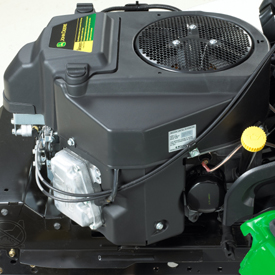 22-hp (16.4-kW) V-twin engine
22-hp (16.4-kW) V-twin engine
The tractor is powered by a John Deere iTorque™ power system, a combination of engine features and an exclusive hood design that provide superior lugging ability, even cooling, and durability.
A 22-hp (16.4-kW) V-twin engine provides plenty of power and torque to handle tough mulching, mowing, and bagging conditions.
Key engine features include:
- 22 hp (16.4 kW)
- Large 726-cc displacement
- V-twin air-cooled design that provides smooth, quiet power
- Quality features include:
- Cast-iron cylinder liners
- Overhead valves
- Full-pressure lubrication
- Replaceable oil filter
- Dual-stage air cleaner V-twin design:
- Excellent power and performance
- Easy starts
- Smooth operation
Flywheel alternator
A flywheel alternator provides plenty of capacity to quickly recharge the battery and power electrical equipment, such as lights or a sprayer:
-
15-amp capacity
- Regulated to keep the battery at full charge without risk of overcharging
Fuel tank has large, 3.3-U.S. gal. (12.5-L) capacity
 Fuel tank
Fuel tank
 Electronic fuel gauge
Electronic fuel gauge
Large fuel tank and convenient fuel gauge minimize the number of stops for fuel and chance of running out of fuel:
- Fuel tank has a large, 3.3-U.S. gal. (12.5-L) capacity for more hours of operation between refills.
- Large, 3-in. (7.6-cm) diameter fuel tank filler opening makes adding fuel easy.
- Located on the left fender
- Helps eliminate spillage
- Electronic fuel gauge on the dash display allows the operator to easily monitor the amount of fuel in the tank.
The 48-in. (122-cm) Accel Deep™ (48A) Mower Deck cuts clean and is versatile
 X394 with Accel Deep 48A Mower
X394 with Accel Deep 48A Mower
 Accel Deep 48A Mower
Accel Deep 48A Mower
The 48-in. (122-cm) Accel Deep Deck uses the latest in three-spindle mowing technology to raise performance to a higher level:
- 10-gauge, 0.135-in. (3.4-mm) deck stamping for long life
- Deep, flat-top deck design to handle a large volume of material at faster mowing speeds
- Gives excellent cut quality and uniform discharge
- Easy to keep clean on top of and under the deck
- Resilient four-point mounting system suspends mower from tractor for a smooth and level cut
- Wide mower wheels easily adjusted just above ground level to help prevent scalping
- 0.25-in. (6.4-mm) cut-height increments allow mower to be set at the desired cut height
- Onboard deck-leveling system makes keeping mower properly adjusted easy
- Compatible with optional MulchControl™ mulching system
- Compatible with high-performance Power Flow™ material collection systems
- For use on X330, X350, X354, X370, X380, X384, X390, X394, X570, X580, X584, and model year 2016 X590 Tractors
The 48-in. (122-cm) Accel Deep Mower Deck is a stamped-steel, deep, flat-top design that delivers excellent cut quality, productivity, cleanliness, durability, and versatility. Optimal performance and dispersion of clippings is provided, even at faster mowing speeds:
- 4.83-in. (12.3-cm) depth throughout the entire deck shell for optimum mowing, mulching, and bagging performance
- Optional lever-action or electric one-touch MulchControl attachment provides superior mulching performance and versatility.
- Stamped-steel design eliminates sharp edges and corners where material can build up and diminish mowing performance
- Mower deck is suspended from the vehicle for a smooth and level cut
- Adjustable mower wheels, positioned just above ground level, help reduce scalping
Excellent cut quality
 48A Mower top (similar mower from X700 Series Tractor shown)
48A Mower top (similar mower from X700 Series Tractor shown)
 48A Mower underside (similar mower from X700 Series Tractor shown)
48A Mower underside (similar mower from X700 Series Tractor shown)
Deep mower-deck stamping gives excellent cut quality. It allows the cut and suspended material room to exit the deck without getting recut:
- Reducing the amount of re-cutting enables more power to be used to cut incoming grass, which greatly improves mower capacity.
- Helps maintain excellent cut quality at faster mowing speeds
- Clean flow of material out of discharge area prevents cut material from interfering with cutting the incoming grass, making it possible for the blades to cut incoming material cleanly.
- Even in mulching mode, cut evenness is improved compared to other designs because the additional depth allows for continuous circulation, optimal re-cutting, and an even distribution of clippings.
Productivity - getting the job done fast
 Right side of Accel Deep 48A Mower Deck
Right side of Accel Deep 48A Mower Deck
Deep mower-deck stamping gives high productivity, which gets the job done fast. It allows the cut and suspended material room to exit the deck quickly, reducing the amount of re-cutting so more power is available to process incoming grass:
- Greatly improves mowers capacity to maintain excellent mowing performance in difficult mowing conditions and at higher speeds
Large discharge opening is both high and wide to handle more material:
- Gives a smooth, even discharge of clippings at all mowing speeds
- Reduces the chance of plugging, especially important when operating in wet, thick, or dense grass and when bagging
- The 48A Power Flow blower has an inlet housing with over 50 percent greater area than the 48X Power Flow blower used on previous machines.
Cleanliness - for the mower and the operator
 Accel Deep 48A Mower Deck
Accel Deep 48A Mower Deck
 Accel Deep 48A Mower Deck
Accel Deep 48A Mower Deck
The flat-top shape of the deck stamping is optimal for keeping itself and the operator clean:
- There are few places to catch and hold material on top and underneath the deck.
- Top of deck stays cleaner, reducing time and effort needed for cleaning and service
- Underside of deck is self-cleaning to maintain optimum performance without buildup of material to interfere with the flow of air and clippings
- Less need to clean and remove buildup of material from underside deck
- The depth of the Accel Deep mower deck minimizes the amount of material that escapes from the front of the deck:
- Limited amount of material to drift onto the operator and mower deck
- Even for material discharged out the chute, less re-cutting results in larger pieces that are less likely to end up on the operator
- Mulching prevents the discharge of material completely and the MulchControl attachment makes mulching a practical solution for most mowing situations.
Cleaning a mower deck, both top and bottom, is one of the most frequent maintenance activities:
- The flat-top design reduces places for material to build up and makes material that does collect easy to remove.
 Mower wash port
Mower wash port
 Mower wash port with hose connector
Mower wash port with hose connector
A wash port is provided to make cleaning the underside of the mower deck easy.
- Hose connector is included with the mower deck.
Superior durability is designed in
 Spindle pocket with flip-up cover
Spindle pocket with flip-up cover
 Easy-to-adjust mower wheel and mower side reinforcement
Easy-to-adjust mower wheel and mower side reinforcement
The 48A Mower Deck has strong spindle pockets, to keep the blades aligned, even after years of tough service:
- Ribs in the deck shell add strength where it is needed.
- The 48A has a 23 percent heavier overall weight than the Edge™ Xtra 48-in. (122-cm) mower deck used on previous machines.
Mower wheels are heavy duty:
- Provides greater strength and durability for longer, trouble-free life.
- Setting wheels to the correct height for the cutting height quick and easy.
Low-tension belt-drive design reduces the side load on engine lower bearings and mower deck bearings for longer life.
The 48A Mower Deck features a 5/8-in. (16-mm) diameter solid-steel rod side bumper that provides extra strength and protection.
Dual-stage E-coat and powder-paint coatings provide extra protection from rust.
Versatility - easy to change between side discharge, mulch, and bagging modes
The 48A Mower is designed for maximum versatility, providing the greatest ease in changing from one mower discharge mode to another:
- With an optional MulchControl attachment installed (along with the special mulching blades), changing from side-discharging to mulching or vice versa is done with the simple flip of a lever or push of an electric switch.
- The Power Flow rear bagger can be used with the MulchControl attachment and blades installed by simply using the MulchControl lever or electric one-touch switch to move the mulch baffle to the side-discharge position.
MulchControl option
A lever-action or electric one-touch MulchControl attachment for the 48A Mower Deck makes mulching more practical for many mowing situations because it not only does an excellent job of mulching but it also allows the mower to be easily converted for times when it is more desirable to side discharge or collect the lawn material. Advantages of mulching grass clippings include:
- A beautiful looking lawn
- Grass clippings not blown onto the operator, driveways, or flower beds
- Less fertilizer use
- Elimination of the effort needed to dispose of clippings
How MulchControl works
 MulchControl baffle open
MulchControl baffle open
 MulchControl baffle closed
MulchControl baffle closed
MulchControl is an innovative, simple design that is easy to use and maintain:
- The MulchControl attachment includes baffles to control the flow of material under the deck.
- The MulchControl baffle, or divider, between the left and middle spindles is about half way down. The height is designed to balance the mulching and side-discharge modes.
- When the MulchControl baffle is open, the divider between the left and middle spindles passes a portion of the material to the discharge opening, along with the material from the middle and right spindle areas.
- When the MulchControl baffle is closed, the material stays within the deck and gets chopped into mulch and deposited in the turf.
 MulchControl handle
MulchControl handle
 Electric one-touch MulchControl switch
Electric one-touch MulchControl switch
- For the lever-action MulchControl attachment, a handle on top of the mower deck is used to engage or disengage mulch mode.
- The operator is required to get off of the tractor in order to engage or disengage mulch mode with the lever-action system.
- For the electric one-touch MulchControl attachment, a switch on the tractor dash is used to engage or disengage mulch mode.
- Changing from mulch mode to side discharge mode or vice versa takes only a few seconds.
MulchControl is well-suited to the following mowing situations:
- Usually mulch, but side discharge when grass gets too long
- Usually side-discharge, but would like to be able to close the chute to control clippings
- Always mulch a main lawn, but often side discharge secondary lawns
- Bag clippings, but want to go farther before emptying bags
MulchControl puts the operator in control of the clippings. The operator can have all the benefits of mulching with the ability to easily change to side discharging or bagging when needed.
While in the side-discharge mode, MulchControl will still mulch about one third of the material. Therefore, the side-discharge mode is essentially a partial-mulch mode. This can be an advantage when side discharging or bagging, as it helps to reduce the amount of material being discharged. Other times this could work as a disadvantage:
- When cutting strong southern grasses, such as Zoysia and Bermuda
- When cutting in wet, high-growth conditions, such as those found in the Pacific Northwest United States
- When optimum bagging and lawn clean-up is desired
7-bu (247-L) Power Flow rear bagger
 Optional rear bagger
Optional rear bagger
 Power Flow blower
Power Flow blower
An optional 7-bu (247-L) rear bagger material collection system (MCS) is available. It provides an efficient means of collecting grass clippings and leaves:
- The Power Flow blower and chute are easy to install. The Power Flow blower swings out for easy cleanout and cleanup.
- The hopper design provides modern styling, great bagging performance, cleaner operation, and easy-to-empty bags:
- 7-bu (247-L) capacity
- Easy-to-attach Power Flow blower (ordered separately)
- Easy-to-attach chute (ordered separately)
- Air exhaust duct
- Convenient spring-latch
- Airflow fill indicator
- Quik-Tatch mounting
- Sealed hopper top
- Loose-knit bags available
Larger 14-bu (493-L) and 19-bu (670-L) MCS are available, in addition to the 7-bu (247-L) MCS, for specific X300 and X500 Series Tractor models.
Four-year or 300-hour bumper-to-bumper warranty is standard
An exclusive 4-year or 300-hour (whichever comes first), single-source, bumper-to-bumper warranty* is standard for all John Deere X300 Series Tractors.
- The warranty is hassle free, with one company handling all of the paperwork.
- Premium features of X300 Series Tractors allow for this longer warranty period, with more coverage than comparable tractors.
*Term limited to years or hours used, whichever comes first, and varies by model. See the LIMITED WARRANTY FOR NEW JOHN DEERE TURF AND UTILITY EQUIPMENT at JohnDeere.com or JohnDeere.ca/TUWarranty for details.
Four-wheel power steering gives superior maneuverability and trimming ability
 Four-wheel steering versus two-wheel steering
Four-wheel steering versus two-wheel steering
 Four-wheel steer maneuverability
Four-wheel steer maneuverability
NOTE: In the schematic above, the solid line refers to a four-wheel steer tractor, and the hashed line refers to a two-wheel steer tractor.
Four-wheel steering provides very significant maneuverability and trimming advantages over that of two-wheel-steering-equipped tractors.
For example, with the X394 Select Series™ Tractor equipped with a 48-in. (122-cm) Accel Deep™ Mower (the following numbers correspond to the schematic above):
- Uncut circle radius is reduced from 24 in. (61 cm) for a two-wheel steer X390 to only 15 in. (38 cm) with an X394, eliminating or greatly reducing the need to back up when trimming around trees, shrubs, etc.
- Interference from the mower and tractor wheels is eliminated because they are several inches away from the object being trimmed around.
- Outside turning circle is reduced, reducing the time spent turning and increasing mowing efficiency.
Also, trimming inside curves around flower beds or other landscaping can be done more completely with a four-wheel steer tractor.
Designed for tight turns
The four-wheel steering system is designed for tight turns, leading to greater mowing efficiency:
-
Caster, camber, and kingpin angles are optimized to reduce effort, especially when going from straight ahead into a turn.
-
Steering geometry has been designed with the use of 3-D modeling, so all four tires are working together.
-
Sealed ball bearings are used on the torque shaft and the rear spindles to reduce friction.
-
Small scrub radius, less than 1 in. (2.5 cm) in the rear, reduces scuffing and bump-steer.
Designed for easy steering
 Four-wheel manual steer illustration shown
Four-wheel manual steer illustration shown
 Four-wheel manual steer illustration shown
Four-wheel manual steer illustration shown
Sealed ball bearings are used at critical all-wheel-steer joints for reduced friction, longer life, and less maintenance.
Easy steering is important for an enjoyable mowing experience:
-
Larger, 14-in. (35.6-cm) diameter steering wheel gives improved leverage for easier turns.
-
Ball-joints on both ends of the steering tie rods reduce wear to maintain accurate steering.
-
Greaseable front steering spindles reduce friction and improve wear over time.
Power steering enables easy turns
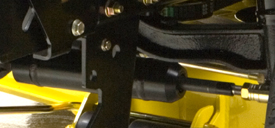 Power steering cylinder
Power steering cylinder
Hydraulic power steering is standard equipment:
- Provides effortless, automotive-like control
- Reduces operator fatigue and increases productivity
- Enables a tight turning radius for great maneuverability
- Adjustable-tilt steering wheel for optimum operator comfort (X390 and X394 Tractor)
Lever-action or electric one-touch MulchControl™ options are available for extra mowing convenience
 Lever-action MulchContol lever
Lever-action MulchContol lever
 Electric one-touch MulchControl switch
Electric one-touch MulchControl switch
Lever-action or electric one-touch MulchControl attachment is available for Accel Deep™ 42-in. (107-cm) (42A), 48-in. (122-cm) (48A), and 54-in. (137-cm) (54A) Mower Decks used on X300 and X500 Select Series™ Tractors.
MulchControl advantages and benefits
MulchControl enhances versatility and productivity. A mower deck equipped with MulchControl not only does an excellent job of mowing and mulching, but it can also be quickly converted from side discharging to mulching or vice versa:
- In mulch mode, it controls clippings dispersion in unwanted areas (driveways, landscape beds, near buildings, windows, parking lots, etc.).
- Reduces cleanup time needed to dispose of clippings.
- Reduces the amount of material entering a material collection system because, even in the side discharge mode, MulchControl will mulch about one third of the material due to the additional baffles under the mower deck and the unique design of the mulching blades.
Electric MulchControl has the additional advantage of being controlled from the tractor seat by a switch on the dash to operate an electric actuator that moves the baffle to close off the discharge area of the mower deck.
 Electric one-touch MulchControl switch
Electric one-touch MulchControl switch
 Electric one-touch MulchControl actuator
Electric one-touch MulchControl actuator
- Operators can convert between modes without interrupting the mowing process, making it practical to change between modes as conditions require.
- When approaching clean areas like driveways or flowerbeds where clippings would be undesirable
- When a breeze might blow clippings back onto the operator
- For side discharge mowing only the areas of the property where grass is too thick for mulching
- With 48A and 54A Mower Decks, for collecting only the areas of the property where grass is too tall or thick for mulching
- With 48A and 54A Mower Decks, the MulchControl baffle can be opened or closed with the Power Flow™ blower installed. The Power Flow blower will run without material when the baffle is closed.
- Models equipped with a 42A Mower Deck require a MulchControl baffle be removed to install the bagger chute; see 42A Mower Deck versatility explanation for more information.
- Changing from one mode to the other takes only a few seconds.
How MulchControl works
A mower equipped with a MulchControl attachment delivers unprecedented levels of productivity and versatility. The operator has the ability to quickly change between side discharging and mulching. A heavy-duty baffle opens and closes to convert the mower from side discharge mode to mulch mode or vice versa.
 MulchControl baffle open (similar mower deck shown)
MulchControl baffle open (similar mower deck shown)
 MulchControl baffle closed (similar mower deck shown)
MulchControl baffle closed (similar mower deck shown)
MulchControl is an innovative, simple design that is easy to use and maintain:
- The MulchControl attachment includes baffles to control the flow of material under the deck.
- When the MulchControl baffle is open, most of the material flows freely out the discharge deflector or into a material collection system.
- When the MulchControl baffle is closed, material stays within the deck and gets chopped into mulch and deposited in the turf.
MulchControl is well-suited to the following mowing situations:
- For operators who usually mulch, but side discharge when grass gets too long
- For operators who usually side discharge, but would like to be able to close the chute to control clippings in some areas
- For operators who always mulch a main lawn, but often side discharge secondary lawns
- For operators who collect clippings, but want to go farther before emptying the material collection system
MulchControl puts the operator in control of the clippings. The operator can have all the benefits of mulching with the ability to easily change to side discharging when desired.
Advantages of MulchControl include:
- Performance is improved.
- Mulching is beneficial because it returns the clippings to the ground as fertilizer, which promotes lawn growth.
- Clippings are much smaller, which allows them to fall into the grass and be removed from view.
- Unsightly grass clippings are not blown onto driveways or into flower beds.
- Fertilizer use is reduced and provides associated environmental benefits.
- Uptime is increased.
- Operators can convert quickly between modes, making it possible to change between mulching and side discharging as conditions require.
- Mulching heavy, thick material can significantly reduce mower productivity. The ability to switch from mulch to side discharge mode ensures productivity, especially in grass too tall or thick to mulch effectively.
- Cost of operation is reduced.
- Controlling clipping dispersion reduces cleanup time.
MulchControl limitations
While in the side discharge mode, MulchControl will still mulch about one third of the material. Therefore, the side discharge mode is essentially a partial mulch mode. This can be an advantage when side discharging or bagging, as it helps to reduce the amount of material being discharged. Other times this could work as a disadvantage:
- When cutting strong southern grasses, such as Zoysia and Bermuda
- When cutting in wet, high growth conditions, such as those found in the Pacific Northwest United States
- When optimum bagging and lawn cleanup is desired
- 42A Mower Deck requires a MulchControl baffle be removed to install the bagger chute
MulchControl compatibility
Each MulchControl attachment includes everything needed: baffles and mulch blades for all attachments, and the actuator, wiring, and switches for the electric one-touch attachments.
Lever-action MulchControl attachments
| Attachment number | Description | Applications |
| BM24794 | 42A MulchControl (lever action) | X300 Series Tractors, Z300 Series ZTrak™ Mowers |
| BM24993 | 48A MulchControl (lever action) | X300 and X500 Series Tractors, Z300 and Z500 Series ZTrak Mowers |
| BM24994 | 54A MulchControl (lever action) | X300 and X500 Series Tractors, Z300 and Z500 Series ZTrak Mowers |
Electric one-touch MulchControl attachments
| Attachment number | Description | Applications |
| BUC10164 | 42A electric one-touch MulchControl | X300 Series Tractors* |
| BUC10165 | 48A electric one-touch MulchControl | X300 and X500 Series Tractors* |
| BUC10166 | 54A electric one-touch MulchControl | X300 and X500 Series Tractors* |
* NOTE: Model year 2016-2017 X300 and X500 Series Tractors (X300 serial number 10,001-50,000 and X500 serial number 110,001-130,000) require replacing the tractor wiring harness and dash panel to use an electric MulchControl attachment.
Snow removal is a strength of lawn tractors
 44-in. (112-cm) Front Blade
44-in. (112-cm) Front Blade
 Snow blower, weather enclosure, and chains on an X300 Series Tractor
Snow blower, weather enclosure, and chains on an X300 Series Tractor
An advantage of lawn tractors is their ability to use equipment for snow removal. Lawn tractor owners can add a John Deere snow blower or front blade to make quick work of moving snow whenever the need arises. Weather enclosure and tire-chain attachments add comfort and performance.
Equipment available for snow removal includes:
- 44-in. (112-cm) Snow Blower
- 44-in. (112-cm) Front Blade
- 48-in. (122-cm) Front Blade (X394 Tractor only)
- Tire chains or TerraGrip traction belts
- Weather enclosure (available for all X300 Series, except the X350R)
- Weights
Integrated hydrostatic transaxle efficiently transmits power to wheels
 Kanzaki® K46 transaxle (X330, X350, X354) Kansaki K57 transaxle (X370)
Kanzaki® K46 transaxle (X330, X350, X354) Kansaki K57 transaxle (X370)
 Kanzaki K58 transaxle (X380, X384, X390, X394)
Kanzaki K58 transaxle (X380, X384, X390, X394)
The Tuff Torq® hydrostatic transaxle encloses the hydrostatic pump and motor rotator groups in the same housing with the differential and axle housings. This design is very efficient and reduces the number of sealing surfaces to minimize the potential for leakage.
Combined with the foot controls, the hydrostatic transmission functions similarly to that of an automatic transmission in an automobile, so the term automatic is often used to describe it:
- Use of the latest valve designs has significantly reduced the sound level.
- Large pump and motor rotating groups ensure long life and efficient operation.
Freewheeling valve
 Freewheeling valve
Freewheeling valve

A freewheeling valve control is conveniently located near the tractor rear hitch plate for good visibility and easy operation.
Kanzaki and Tuff Torq are trademarks of Kanzaki Kokyukoki Manufacturing Company.
Power steering and hydraulic lift enable easy operation
 Power steering cylinder
Power steering cylinder
 Tilt steering lever (X390 and X394 only)
Tilt steering lever (X390 and X394 only)
Hydraulic power steering is standard equipment:
- Provides effortless, automotive-like control
- Reduces operator fatigue and increases productivity
- Enables a tight turning radius for great maneuverability
- Adjustable-tilt steering wheel for optimum operator comfort (X390 and X394 Tractor)
Hydraulic lift system is easy to operate
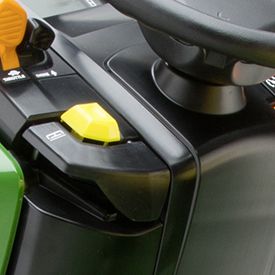 Hydraulic lift
Hydraulic lift
The hydraulic lift control lever is positioned on the dash near the steering wheel for quick, easy, and precise fingertip control of equipment. Implement float, which allows an implement to follow the ground contour, is built into the lift linkage.
Controls are convenient and easy to find
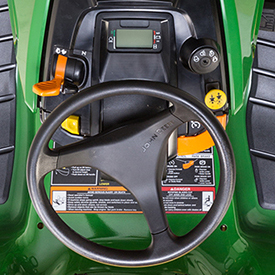 Convenient operator station
Convenient operator station
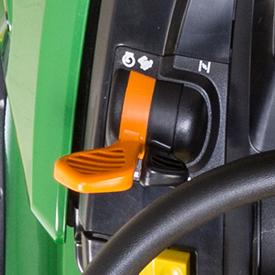 Separate throttle and choke controls
Separate throttle and choke controls
The contoured dash has clean, attractive styling and ergonomic controls for easy use:
- Controls are color coded for easy identification by the operator.
- Controls are logically placed and easy to reach.
- The power take-off (PTO) switch allows the operator to get fingers underneath it, like a T-handle, to pull up for easy activation.
- The reverse implement option (RIO) switch is a yellow button.
- The hydraulic-lift control and the park brake latch are pivot levers for low effort.
- Cruise control activation is handled by an automotive-style button.
- Separate engine speed and choke controls make starting and warming up the engine easier in cold weather.
- The choke lever is spring loaded to eliminate the chance the tractor will be unintentionally operated with the choke partially closed.
Functional design of the throttle and choke controls provides good appearance and a comfortable feel.
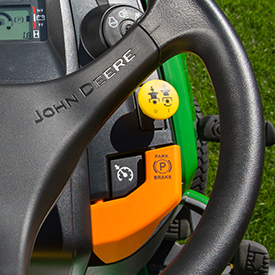 Easy-to-use key switch and controls
Easy-to-use key switch and controls
 Tilt steering lever (X390 and X394 only)
Tilt steering lever (X390 and X394 only)
- The hydraulic-lift control and the park brake latch are pivot levers for low effort.
- Cruise control activation is handled by an automotive-style button.
- Separate engine speed and choke controls make starting and warming up the engine easier in cold weather.
- The choke lever is spring loaded to eliminate the chance the tractor will be unintentionally operated with the choke partially closed.
- Functional design of the throttle and choke controls provides good appearance and a comfortable feel.
- Power steering takes the work out of turns.
- Tilt steering wheel adjusts for operator comfort (X390, X394).
Twin Touch™ foot control
 Twin Touch foot control
Twin Touch foot control
 Cruise control
Cruise control
Twin Touch foot pedals control the speed and direction of travel:
- Automotive-type accelerator control ensures easy operation.
- Operator can change direction without lifting foot off the platform.
- Large pedal surface gives superior operator comfort.
Cruise control
Cruise control is standard equipment:
- To engage, push the cruise-control button and hold until the foot is removed from the forward pedal.
- For emergency stop, the cruise control can be released by pushing on the brake pedal or the forward pedal.
Mower deck height adjustment
 Conveniently-located deck height adjustment knob
Conveniently-located deck height adjustment knob
 Mower cut-height adjusting knob
Mower cut-height adjusting knob
A rotary dial knob makes adjusting the mower cut height quick and easy:
- Provides mower cut heights in 0.25-in. (6.4-cm) increments from 1 in. (2.5 cm) to 4 in. (10.2 cm)
- Returns the mower deck to the same preset height each time it is lowered
 Storage tray under tractor seat
Storage tray under tractor seat
 Exact Adjust tool used to level mower deck
Exact Adjust tool used to level mower deck
Storage for the onboard deck-leveling gauge and the Exact Adjust tool is provided in the storage tray under the tractor’s seat.
- Exact Adjust ports allow for easy and accurate leveling of the mower deck for optimum mowing performance.
 Deck-leveling gauge placed under deck
Deck-leveling gauge placed under deck
Deck-leveling gauge is placed at the appropriate location under the left rear, right rear, and front of the mower deck as the cut height is adjusted using the Exact Adjust tool and front draft arm adjusting nuts.
Parking brake control
 Parking brake
Parking brake
Depressing the brake pedal applies internal wet-disk brakes (increased durability and longer life) for safe stopping.
A parking brake control is conveniently located for easy access; it holds the brake pedal securely in locked position.
Electric power take-off (PTO) clutch is easy and convenient to use
 Electric PTO switch
Electric PTO switch
The heavy-duty electric PTO clutch is operated with a convenient dash-mounted switch.
Heavy-duty PTO clutch
 PTO clutch
PTO clutch
The PTO clutch is designed to operate through many on/off cycles.
Reverse implement option (RIO)
 Reverse implement switch
Reverse implement switch
 Mower engagement power take-off (PTO) switch
Mower engagement power take-off (PTO) switch
Using RIO
CAUTION: Children or bystanders may be injured by rotating blades. Before traveling forward or rearward:
- Carefully check the area around the machine.
- Disengage the mower before backing up.
NOTE: Operating the mower while backing up is strongly discouraged. RIO should be used only when operating another attachment or when the operator deems it necessary to reposition the machine with the mower engaged.
- Stop forward travel. Allow attachment to run.
- Look down and behind the machine to be sure that there are no bystanders.
- Push and hold in the reverse implement switch while depressing the reverse pedal slightly.
NOTE: If the attachment stops while positioning the machine, return mower engagement (PTO) switch to off position. Repeat this procedure from the beginning. - Release the reverse implement switch and reposition the machine as the machine begins to move rearward.
- Resume forward travel. The attachment should continue operating.
- Repeat procedure to position the machine again.
Display panel
 Display panel illustration with descriptions
Display panel illustration with descriptions
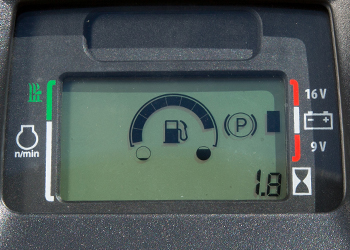 Display panel
Display panel
Instrument display has the look and feel of a modern automobile. A power-up sequence cycles lights and gauges to indicate they are working:
- Display features dark-cockpit design to minimize operator distractions.
- Display is back lit for night visibility.
- Night visibility is especially useful with snow blower use.
- Hour meter makes it easy to tell when oil changes and other maintenance should be performed.
- Electronic fuel gauge provides real-time fuel level information.
- A tachometer graphically displays engine speed.
- Target-zone graphics inform the operator of the engine speed range to use for best cut quality.
- An indicator tells the operator when the PTO is operating.
- Bright caution and stop lights capture the operator's attention when important information is on the instrument cluster.
- Damage can be prevented and repair costs reduced by addressing problems early.
- Operators are advised of what the problem is if they attempt to operate the mower with unsatisfied PTO, seat, or park brake interlocks.
- The indicators are also useful to identify the reasons the PTO or engine may have shut off when an interlock is unsatisfied.
- Operators are advised if battery voltage is low, normal, or excessive.
- The service indicator light illuminates to indicate a diagnostic error code is stored.
- Onboard diagnostics provides trouble codes for use by trained technicians.
- For example, a technician will be able to test switch functionality and circuit continuity without tools.
- Onboard diagnostics provides trouble codes for use by trained technicians.
Frame is reliable heavy-duty welded steel
 Welded, heavy-duty frame
Welded, heavy-duty frame

The frame is made of heavy formed and welded steel, reinforced in critical areas for even greater strength:
- The frame is formed from 12-gauge, 0.105-in. (2.66-mm) thick material for long life.
- Standard front bumper and hitch plate are formed from 9-gauge, 0.15-in. (3.8-mm) steel and complete the frame assembly.
- Rear hitch plate can support two 42-lb (19-kg) Quik-Tatch weights.
- Weight bracket is built into the frame of two-wheel-steer models.
- Four-wheel-steer models require the optional weight bracket.
Front axle and wheel spindles are heavy-duty
 Cast-iron front axle
Cast-iron front axle
Front axle is made of nodular cast iron:
- Cast-iron front axle is strong and shock-resistant.
- Cast iron will not yield under heavy loads or impact.
A replaceable bushing is used at axle mounting:
- The bushing provides excellent wear resistance.
- Grease fittings at each spindle are easy to service.
Front steering spindles
 Steering spindle
Steering spindle
Front steering spindle diameter is 0.75 in. (19 mm) for strength and long life:
- Have strength to handle heavy implements
- Provide long life at bearing surfaces
- Use sealed precision bearings in front wheels
Rear equipment-mounting system is heavy-duty and easy to use
 Rear equipment mounting system
Rear equipment mounting system
A heavy-duty equipment mounting system is used:
- Includes strong frame mounts with a combination of mounting holes in the tractor hitch plate that accept pins or shoulder bolts to support heavy rear-mounted equipment.
- Easily attach optional equipment to the tractor
- Can bear the load of heavy rear-mounted equipment, such as material collection systems
Modern styling with functional design enhances appearance and performance
 Attractive styling
Attractive styling
 Hood air-intake louvers
Hood air-intake louvers
Smooth, rounded contours present a modern, styled appearance:
- Hood styling incorporates efficient full-length air-intake louvers on each side, rather than on the top.
- Cooler engine operation
- Lower operator station sound levels
- Hot air is vented out the front grille, away from the operator.
- The fully enclosed hood is made of molded-in-color material.
- Reduces sound
- Will not rust or dent
- Distinctive grille and large, one-piece fender deck complete the styling package.
Two high-quality headlights give excellent visibility
 Optimum lighting pattern
Optimum lighting pattern
Headlights are standard equipment on all models:
- Two 27-W bulbs provide excellent lighting for good visibility during evening operation.
- A headlight position on the ignition switch makes it easy to operate the headlights.
- The headlights are designed to provide an optimum lighting pattern for mowing and snow removal.
Operator station is comfortable and convenient
 Operator station
Operator station
 Operator station
Operator station
The operator station is designed for operator comfort and ease of using controls:
- A large, 14-in. (36-cm) diameter steering wheel is comfortable to use and minimizes steering effort.
- Full-length foot mats provide comfort for the operator and protect the footrest area.
Comfortable seat
 Comfortable open-back seat
Comfortable open-back seat

An open-back 15-in. (38-cm) high-back seat provides a comfortable, smooth ride and good support for the operator:
- Seat travel of 7 in. (18 cm) with 15 positions allows the operator to be seated comfortably and easily operate the controls.
- Seat can be easily adjusted fore and aft by the operator while sitting on the seat.
- Open-back design allows air circulation to keep the operator's back cool and dry for a more comfortable ride.
- Grasp at the top of the seat is conveniently located for use when tilting the seat up to protect it from the weather.
Seat suspension
 Seat suspension
Seat suspension

The seat suspension is adjustable, without tools, for the weight of the operator:
- Springs are adjustable fore and aft to any of three positions.
- No tools require
- Allows fine-tuning of the suspension for the operator's weight
- Back position for more support for heavier operators
- Tool tray is designed into the seat base.
- Can be used to store gloves, small tools, etc.
- Provides storage location for Exact Adjust tool and deck-leveling gauge (tool and depth-leveling gauge not shown in photo)
Cup holder
 Cup holder and tool tray on fender
Cup holder and tool tray on fender
A cup holder and tool tray are located on the fender for operator convenience:
- The cup holder holds a variety of container sizes.
- Tool tray provides convenient storage.
- Cup holder and tool tray are constructed of durable acrylonitrile butadiene styrene (ABS) plastic.
Removable plug for optional 12-V outlet
 Location for optional 12-V outlet
Location for optional 12-V outlet
A removable plug on the console, in front of the operator, provides a convenient location for the optional 12-V outlet and makes installation easy.
- Convenient for plugging in cell phone charger and other electric devices
- Can be used to operate electric rear equipment, such as a sprayer or spreader
12-V fast connector
 Illustration of fast connector location
Illustration of fast connector location
A mid-vehicle, 12-V fast connector, located under the tractor’s fuse box, is included as standard equipment to reduce initial installation time for some attachments that operate on 12-V power from the tractor:
- The four-cavity connector includes battery, ground, and key switch terminals and is turned on and off with the ignition switch.
Serviceability is convenient with easy-open hood
 One-piece hood is easy to open
One-piece hood is easy to open
 Service interval decal located under hood
Service interval decal located under hood
The one-piece hood opens easily to permit checking and servicing the engine:
- Important service points are located within easy reach.
- A service-interval decal is provided inside the tractor hood for convenience when servicing the tractor.
- The high-quality engine used in the X300 Series does not require an 8-hour oil and filter change because improvements in the manufacturing process and quality of parts, components, and oils have eliminated the need for the short interval oil change requirement.
 Easy-to-service engine fuel and oil filters
Easy-to-service engine fuel and oil filters
The engine fuel and oil filters, the oil check/fill tube, and the oil drain tube are exposed for serviceability when the hood is opened.
Exact Adjust ports and onboard deck-leveling tools make precise deck adjustments easy
 Deck-leveling gauge and hex adjusting tool stored under tractor seat
Deck-leveling gauge and hex adjusting tool stored under tractor seat
 Exact Adjust access holes
Exact Adjust access holes
A mower deck must be level side-to-side and properly adjusted front-to-rear to give the best cutting performance. A removable onboard deck-leveling gauge and a hex-key tool are provided to make adjustment easy. They are securely stored under the tractor seat.
Exact Adjust leveling ports are provided on each side of the operator platform above the mower-level adjusting bolts. With the hex-shaped tool, they provide convenient access to allow quick and easy adjustment of the mower for the best-cut quality of cut.
The Exact Adjust feature is standard on all Select Series™ X300 and X500 Tractors:
- There is no need to reach under the fender deck while making the mower-level adjustment.
- Onboard deck-leveling gauge, Exact Adjust ports, and the hex tool work together.
- Level the mower deck side to side
- Set the correct amount of rake (front-to-back deck orientation)
- Calibrate the cutting height to the cut-height adjusting knob setting
- Exact Adjust simplifies leveling the mower deck if equipped with a Power Flow™ blower.
- To give the best cut, mower level should be adjusted if alternately mowing with and without blower installed. The Exact Adjust feature makes this easy.
 Deck-leveling tool placed under deck
Deck-leveling tool placed under deck
 Using included ball-hex tool to level mower deck
Using included ball-hex tool to level mower deck
Consult the operator's manual for the correct adjusting procedures for each tractor model. Basic adjusting steps to properly level the mower deck include:
- Park the tractor on a level surface.
- Inflate tires to the correct pressure.
- Consult the label for the cutting-height knob that is located on the console of the machine. This label shows deck-leveling position and location of deck-leveling adjustment points.
 Cut height adjusting knob
Cut height adjusting knob
- Set mower cutting-height knob to the correct deck-leveling position.
- For X300 models, use position 2.75
- For all other models, use position 2.5
- Adjust mower wheels as necessary so they do not contact the ground surface.
- Remove the onboard deck-leveling gauge that is located under the seat.
- Using the Exact Adjust ports and tool, adjust mower deck side-to-side level so the deck-leveling gauge just slips under the left and right lower deck rim at the designated adjustment points. The location of adjustment points will vary slightly between decks.
- Left- and right-rear adjustment points are under the deck rim near the rear mower wheels, if equipped.
- Adjust mower deck front-to-back level, if necessary.
- Loosen rear nuts equally on each side of front lift rod.
- Turn front nut equally on each side clockwise to raise front of mower or counterclockwise to lower it until gauge just slips under the front adjustment point.
- Tighten rear nuts after adjustment is complete.
- Return the gauge to its storage position.
NOTE: The adjusting tool supplied with the tractor is an 8-mm ball-hex key, part number M162737. The rounded end allows for some misalignment with the bolt as the deck is adjusted.
The MowerPlus™ app helps maintain the tractor and lawn
 MowerPlus app screen
MowerPlus app screen
 MowerPlus app maintenance screen
MowerPlus app maintenance screen
Keep a John Deere riding lawn mower running its best and know how it mows with the John Deere MowerPlus app. Simply scan the lawn tractor’s barcode to get custom information. The app helps determine the best time to mow, communicates expert pre-mow tips, offers maintenance reminders, and provides walk-through guides.
Look for the MowerPlus app on the mobile device’s app store.
The app supports residential lawn equipment such as 100 Series, S240, X300, X500, X700, Z200 through Z600, and many similarly-sized older products. It does not presently support tractor models numbered 1000 and larger, such as 1025R.
NOTE: Some product image variation may exist.
Also available is the John Deere MowerPlus smart connector (sold separately).
 Smart connector
Smart connector
The John Deere MowerPlus smart connector wirelessly links a Select Series™ X300 or X500 Tractor to the MowerPlus app on a mobile device. The smart connector transmits engine usage to the app, making it easy to track maintenance intervals. It also transmits the fuel level to the app—when thinking ahead about Saturday morning mowing, the operator can make sure the tractor is fueled and ready to go.
Features
Engine is smooth running and reliable V-twin air-cooled design
 22-hp (16.4-kW) V-twin engine
22-hp (16.4-kW) V-twin engine
The tractor is powered by a John Deere iTorque™ power system, a combination of engine features and an exclusive hood design that provide superior lugging ability, even cooling, and durability.
A 22-hp (16.4-kW) V-twin engine provides plenty of power and torque to handle tough mulching, mowing, and bagging conditions.
Key engine features include:
- 22 hp (16.4 kW)
- Large 726-cc displacement
- V-twin air-cooled design that provides smooth, quiet power
- Quality features include:
- Cast-iron cylinder liners
- Overhead valves
- Full-pressure lubrication
- Replaceable oil filter
- Dual-stage air cleaner V-twin design:
- Excellent power and performance
- Easy starts
- Smooth operation
Flywheel alternator
A flywheel alternator provides plenty of capacity to quickly recharge the battery and power electrical equipment, such as lights or a sprayer:
-
15-amp capacity
- Regulated to keep the battery at full charge without risk of overcharging
Fuel tank has large, 3.3-U.S. gal. (12.5-L) capacity
 Fuel tank
Fuel tank
 Electronic fuel gauge
Electronic fuel gauge
Large fuel tank and convenient fuel gauge minimize the number of stops for fuel and chance of running out of fuel:
- Fuel tank has a large, 3.3-U.S. gal. (12.5-L) capacity for more hours of operation between refills.
- Large, 3-in. (7.6-cm) diameter fuel tank filler opening makes adding fuel easy.
- Located on the left fender
- Helps eliminate spillage
- Electronic fuel gauge on the dash display allows the operator to easily monitor the amount of fuel in the tank.
The 54-in. (137-cm) Accel Deep™ (54A) Mower Deck cuts clean and is versatile
 X394 with Accel Deep 54A Mower
X394 with Accel Deep 54A Mower
 Accel Deep 54A Mower
Accel Deep 54A Mower
The 54-in. (137-cm) Accel Deep Deck uses the latest in three-spindle mowing technology to raise performance to a higher level:
- 10-gauge, 0.135-in. (3.4-mm) deck stamping for long life
- Deep, flat-top deck design to handle a large volume of material at faster mowing speeds
- Gives excellent cut quality and uniform discharge
- Easy to keep clean on top of and under the deck
- Resilient four-point mounting system suspends mower from tractor for a smooth and level cut
- Wide mower wheels easily adjusted just above ground level to help prevent scalping
- 0.25-in. (6.4-mm) cut-height increments allow mower to be set at the desired cut height
- Onboard deck-leveling system makes keeping mower properly adjusted easy
- Compatible with optional MulchControl™ mulching system
- Compatible with high-performance Power Flow™ material collection systems
- For use on X380, X384, X390, X394, X570, X580, X584, and model year 2016 X590 Tractors
The 54-in. (137-cm) Accel Deep Mower Deck is a stamped-steel, deep, flat-top design that delivers excellent cut quality, productivity, cleanliness, durability, and versatility. Optimal performance and dispersion of clippings is provided, even at faster mowing speeds:
- 4.83-in. (12.3-cm) depth throughout the entire deck shell for optimum mowing, mulching, and bagging performance
- Optional lever-action or electric one-touch MulchControl attachment provides superior mulching performance and versatility.
- Stamped-steel design eliminates sharp edges and corners where material can build up and diminish mowing performance
- Mower deck is suspended from the vehicle for a smooth and level cut
- Adjustable mower wheels, positioned just above ground level, help reduce scalping
Excellent cut quality
 54A Mower top
54A Mower top
 54A Mower underside
54A Mower underside
Deep mower-deck stamping gives excellent cut quality. It allows the cut and suspended material room to exit the deck without getting recut:
- Reducing the amount of re-cutting enables more power to be used to cut incoming grass, which greatly improves mower capacity.
- Helps maintain excellent cut quality at faster mowing speeds
- Clean flow of material out of discharge area prevents cut material from interfering with cutting the incoming grass, making it possible for the blades to cut incoming material cleanly.
- Even in mulching mode, cut evenness is improved compared to other designs because the additional depth allows for continuous circulation, optimal re-cutting, and an even distribution of clippings.
Productivity - getting the job done fast
 Right side of Accel Deep 54A Mower Deck
Right side of Accel Deep 54A Mower Deck
Deep mower-deck stamping gives high productivity, which gets the job done fast. It allows the cut and suspended material room to exit the deck quickly, reducing the amount of re-cutting so more power is available to process incoming grass:
- Greatly improves mowers capacity to maintain excellent mowing performance in difficult mowing conditions and at higher speeds
Large discharge opening is both high and wide to handle more material:
- Gives a smooth, even discharge of clippings at all mowing speeds
- Reduces the chance of plugging, especially important when operating in wet, thick, or dense grass and when bagging
- The 54A Power Flow blower has an inlet housing with over 20 percent greater area than the 54X Power Flow blower used on previous machines.
Cleanliness - for the mower and the operator
 Accel Deep 54A Mower Deck
Accel Deep 54A Mower Deck
 Accel Deep 54A Mower Deck
Accel Deep 54A Mower Deck
The flat-top shape of the deck stamping is optimal for keeping itself and the operator clean:
- There are few places to catch and hold material on top and underneath the deck.
- Top of deck stays cleaner, reducing time and effort needed for cleaning and service
- Underside of deck is self-cleaning to maintain optimum performance without build-up of material to interfere with the flow of air and clippings
- Less need to clean and remove build-up of material from underside deck
- The depth of the Accel Deep mower deck minimizes the amount of material that escapes from the front of the deck:
- Limited amount of material to drift onto the operator and mower deck
- Even for material discharged out the chute, less re-cutting results in larger pieces that are less likely to end up on the operator
- Mulching prevents the discharge of material completely and a MulchControl attachment makes mulching a practical solution for most mowing situations.
Cleaning a mower deck, both top and bottom, is one of the most frequent maintenance activities:
- The flat-top design reduces places for material to build up and makes material that does collect easy to remove.
 Mower wash port
Mower wash port
 Mower wash port with hose connector
Mower wash port with hose connector
A wash port is provided to make cleaning the underside of the mower deck easy.
- Hose connector is included with the mower deck.
How MulchControl works
 MulchControl baffle open
MulchControl baffle open
 MulchControl baffle closed
MulchControl baffle closed
MulchControl is an innovative, simple design that is easy to use and maintain:
- The MulchControl attachment includes baffles to control the flow of material under the deck.
- The MulchControl baffle, or divider, between the left and middle spindles is about half way down. The height is designed to balance the mulch and side-discharge modes.
- When the MulchControl baffle is open, the divider between the left and middle spindles passes a portion of the material to the discharge opening, along with the material from the middle and right spindle areas.
- When the MulchControl baffle is closed, the material stays within the deck and gets chopped into mulch and deposited in the turf.
Versatility - easy to change between side discharge, mulch, and bagging modes
The 54A Mower is designed for maximum versatility, providing the greatest ease in changing from one mower discharge mode to another:
- With an optional MulchControl attachment installed (along with the special mulching blades), changing from mulch mode to side discharge mode or vice versa is done with the simple flip of a lever or touch of an electric switch.
- The Power Flow rear bagger can be used with the MulchControl attachment and blades installed by simply using the MulchControl lever or electric one-touch switch to move the MulchControl baffle to the side-discharge position.
MulchControl option
A MulchControl attachment for the 54A Mower Deck makes mulching more practical for many mowing situations because it not only does an excellent job of mulching but it also allows the mower to be easily converted for times when it is more desirable to side discharge or collect the lawn material. Advantages of mulching grass clippings include:
- A beautiful looking lawn
- Grass clippings not blown onto the operator, driveways, or flower beds
- Less fertilizer use
- Elimination of the effort needed to dispose of clippings
 MulchControl handle
MulchControl handle
 Electric one-touch MulchControl switch
Electric one-touch MulchControl switch
- For the lever-action MulchControl attachment, the MulchControl lever on top of the mower deck is used to engage or disengage mulch mode.
- The operator is required to get off of the tractor in order to engage or disengage mulch mode with the lever-action system.
- For the electric one-touch MulchControl attachment, the electric switch on the tractor dash is used to engage or disengage mulch mode.
- Changing from mulch mode to side discharge mode or vice versa takes only a few seconds.
MulchControl is well-suited to the following mowing situations:
- Usually mulch, but side discharge when grass gets too long
- Usually side-discharge, but would like to be able to close the chute to control clippings
- Always mulch a main lawn, but often side discharge secondary lawns
- Bag clippings, but want to go farther before emptying bags
MulchControl puts the operator in control of the clippings. The operator can have all the benefits of mulching with the ability to easily change to side discharging or bagging when needed.
Superior durability is designed in
 Spindle pocket with flip-up cover
Spindle pocket with flip-up cover
 Easy-to-adjust mower wheel and mower side reinforcement
Easy-to-adjust mower wheel and mower side reinforcement
The 54A Mower Deck has strong spindle pockets, to keep the blades aligned, even after years of tough service:
- Ribs in the deck shell add strength where it is needed.
- The 54A has a 3 percent heavier overall weight than the Edge™ Xtra 54-in. (137-cm) mower deck used on previous machines.
Mower wheels are heavy duty:
- Provides greater strength and durability for longer, trouble-free life.
- Setting wheels to the correct height for the cutting height quick and easy.
Low-tension belt-drive design reduces the side load on engine lower bearings and mower deck bearings for longer life.
The 54A Mower Deck features a 5/8-in. (16-mm) diameter solid-steel rod side bumper that provides extra strength and protection.
Dual-stage E-coat and powder-paint coatings provide extra protection from rust.
While in the side-discharge mode, MulchControl will still mulch about one third of the material. Therefore, the side-discharge mode is essentially a partial-mulch mode. This can be an advantage when side discharging or bagging, as it helps to reduce the amount of material being discharged. Other times this could work as a disadvantage:
- When cutting strong southern grasses, such as Zoysia and Bermuda
- When cutting in wet, high-growth conditions, such as those found in the Pacific Northwest United States
- When optimum bagging and lawn clean-up is desired
7-bu (247-L) Power Flow rear bagger
 Optional 7-bu (247-L) rear bagger
Optional 7-bu (247-L) rear bagger
 Power Flow blower
Power Flow blower
An optional 7-bu (247-L) rear bagger material collection system (MCS) is available. It provides an efficient means of collecting grass clippings and leaves:
- The Power Flow blower and chute are easy to install. The Power Flow blower swings out for easy cleanout and cleanup.
- The hopper design provides modern styling, great bagging performance, cleaner operation, and easy-to-empty bags:
- 7-bu (247-L) capacity
- Easy-to-attach Power Flow blower (ordered separately)
- Easy-to-attach chute (ordered separately)
- Air exhaust duct
- Convenient spring-latch
- Airflow fill indicator
- Quik-Tatch mounting
- Sealed hopper top
- Loose-knit bags available
Larger 14-bu (493-L) and 19-bu (670-L) MCS are available, in addition to the 7-bu (247-L) MCS, for specific X300 and X500 Series Tractor models.
Four-year or 300-hour bumper-to-bumper warranty is standard
An exclusive 4-year or 300-hour (whichever comes first), single-source, bumper-to-bumper warranty* is standard for all John Deere X300 Series Tractors.
- The warranty is hassle free, with one company handling all of the paperwork.
- Premium features of X300 Series Tractors allow for this longer warranty period, with more coverage than comparable tractors.
*Term limited to years or hours used, whichever comes first, and varies by model. See the LIMITED WARRANTY FOR NEW JOHN DEERE TURF AND UTILITY EQUIPMENT at JohnDeere.com or JohnDeere.ca/TUWarranty for details.
Power steering and hydraulic lift enable easy operation
 Power steering cylinder
Power steering cylinder
 Tilt steering lever (X390 and X394 only)
Tilt steering lever (X390 and X394 only)
Hydraulic power steering is standard equipment:
- Provides effortless, automotive-like control
- Reduces operator fatigue and increases productivity
- Enables a tight turning radius for great maneuverability
- Adjustable-tilt steering wheel for optimum operator comfort (X390 and X394 Tractor)
Hydraulic lift system is easy to operate
 Hydraulic lift
Hydraulic lift
The hydraulic lift control lever is positioned on the dash near the steering wheel for quick, easy, and precise fingertip control of equipment. Implement float, which allows an implement to follow the ground contour, is built into the lift linkage.
Lever-action or electric one-touch MulchControl™ options are available for extra mowing convenience
 Lever-action MulchContol lever
Lever-action MulchContol lever
 Electric one-touch MulchControl switch
Electric one-touch MulchControl switch
Lever-action or electric one-touch MulchControl attachment is available for Accel Deep™ 42-in. (107-cm) (42A), 48-in. (122-cm) (48A), and 54-in. (137-cm) (54A) Mower Decks used on X300 and X500 Select Series™ Tractors.
MulchControl advantages and benefits
MulchControl enhances versatility and productivity. A mower deck equipped with MulchControl not only does an excellent job of mowing and mulching, but it can also be quickly converted from side discharging to mulching or vice versa:
- In mulch mode, it controls clippings dispersion in unwanted areas (driveways, landscape beds, near buildings, windows, parking lots, etc.).
- Reduces cleanup time needed to dispose of clippings.
- Reduces the amount of material entering a material collection system because, even in the side discharge mode, MulchControl will mulch about one third of the material due to the additional baffles under the mower deck and the unique design of the mulching blades.
Electric MulchControl has the additional advantage of being controlled from the tractor seat by a switch on the dash to operate an electric actuator that moves the baffle to close off the discharge area of the mower deck.
 Electric one-touch MulchControl switch
Electric one-touch MulchControl switch
 Electric one-touch MulchControl actuator
Electric one-touch MulchControl actuator
- Operators can convert between modes without interrupting the mowing process, making it practical to change between modes as conditions require.
- When approaching clean areas like driveways or flowerbeds where clippings would be undesirable
- When a breeze might blow clippings back onto the operator
- For side discharge mowing only the areas of the property where grass is too thick for mulching
- With 48A and 54A Mower Decks, for collecting only the areas of the property where grass is too tall or thick for mulching
- With 48A and 54A Mower Decks, the MulchControl baffle can be opened or closed with the Power Flow™ blower installed. The Power Flow blower will run without material when the baffle is closed.
- Models equipped with a 42A Mower Deck require a MulchControl baffle be removed to install the bagger chute; see 42A Mower Deck versatility explanation for more information.
- Changing from one mode to the other takes only a few seconds.
How MulchControl works
A mower equipped with a MulchControl attachment delivers unprecedented levels of productivity and versatility. The operator has the ability to quickly change between side discharging and mulching. A heavy-duty baffle opens and closes to convert the mower from side discharge mode to mulch mode or vice versa.
 MulchControl baffle open (similar mower deck shown)
MulchControl baffle open (similar mower deck shown)
 MulchControl baffle closed (similar mower deck shown)
MulchControl baffle closed (similar mower deck shown)
MulchControl is an innovative, simple design that is easy to use and maintain:
- The MulchControl attachment includes baffles to control the flow of material under the deck.
- When the MulchControl baffle is open, most of the material flows freely out the discharge deflector or into a material collection system.
- When the MulchControl baffle is closed, material stays within the deck and gets chopped into mulch and deposited in the turf.
MulchControl is well-suited to the following mowing situations:
- For operators who usually mulch, but side discharge when grass gets too long
- For operators who usually side discharge, but would like to be able to close the chute to control clippings in some areas
- For operators who always mulch a main lawn, but often side discharge secondary lawns
- For operators who collect clippings, but want to go farther before emptying the material collection system
MulchControl puts the operator in control of the clippings. The operator can have all the benefits of mulching with the ability to easily change to side discharging when desired.
Advantages of MulchControl include:
- Performance is improved.
- Mulching is beneficial because it returns the clippings to the ground as fertilizer, which promotes lawn growth.
- Clippings are much smaller, which allows them to fall into the grass and be removed from view.
- Unsightly grass clippings are not blown onto driveways or into flower beds.
- Fertilizer use is reduced and provides associated environmental benefits.
- Uptime is increased.
- Operators can convert quickly between modes, making it possible to change between mulching and side discharging as conditions require.
- Mulching heavy, thick material can significantly reduce mower productivity. The ability to switch from mulch to side discharge mode ensures productivity, especially in grass too tall or thick to mulch effectively.
- Cost of operation is reduced.
- Controlling clipping dispersion reduces cleanup time.
MulchControl limitations
While in the side discharge mode, MulchControl will still mulch about one third of the material. Therefore, the side discharge mode is essentially a partial mulch mode. This can be an advantage when side discharging or bagging, as it helps to reduce the amount of material being discharged. Other times this could work as a disadvantage:
- When cutting strong southern grasses, such as Zoysia and Bermuda
- When cutting in wet, high growth conditions, such as those found in the Pacific Northwest United States
- When optimum bagging and lawn cleanup is desired
- 42A Mower Deck requires a MulchControl baffle be removed to install the bagger chute
MulchControl compatibility
Each MulchControl attachment includes everything needed: baffles and mulch blades for all attachments, and the actuator, wiring, and switches for the electric one-touch attachments.
Lever-action MulchControl attachments
| Attachment number | Description | Applications |
| BM24794 | 42A MulchControl (lever action) | X300 Series Tractors, Z300 Series ZTrak™ Mowers |
| BM24993 | 48A MulchControl (lever action) | X300 and X500 Series Tractors, Z300 and Z500 Series ZTrak Mowers |
| BM24994 | 54A MulchControl (lever action) | X300 and X500 Series Tractors, Z300 and Z500 Series ZTrak Mowers |
Electric one-touch MulchControl attachments
| Attachment number | Description | Applications |
| BUC10164 | 42A electric one-touch MulchControl | X300 Series Tractors* |
| BUC10165 | 48A electric one-touch MulchControl | X300 and X500 Series Tractors* |
| BUC10166 | 54A electric one-touch MulchControl | X300 and X500 Series Tractors* |
* NOTE: Model year 2016-2017 X300 and X500 Series Tractors (X300 serial number 10,001-50,000 and X500 serial number 110,001-130,000) require replacing the tractor wiring harness and dash panel to use an electric MulchControl attachment.
Snow removal is a strength of lawn tractors
 44-in. (112-cm) Front Blade
44-in. (112-cm) Front Blade
 Snow blower, weather enclosure, and chains on an X300 Series Tractor
Snow blower, weather enclosure, and chains on an X300 Series Tractor
An advantage of lawn tractors is their ability to use equipment for snow removal. Lawn tractor owners can add a John Deere snow blower or front blade to make quick work of moving snow whenever the need arises. Weather enclosure and tire-chain attachments add comfort and performance.
Equipment available for snow removal includes:
- 44-in. (112-cm) Snow Blower
- 44-in. (112-cm) Front Blade
- 48-in. (122-cm) Front Blade (X394 Tractor only)
- Tire chains or TerraGrip traction belts
- Weather enclosure (available for all X300 Series, except the X350R)
- Weights
Integrated hydrostatic transaxle efficiently transmits power to wheels
 Kanzaki® K46 transaxle (X330, X350, X354) Kansaki K57 transaxle (X370)
Kanzaki® K46 transaxle (X330, X350, X354) Kansaki K57 transaxle (X370)
 Kanzaki K58 transaxle (X380, X384, X390, X394)
Kanzaki K58 transaxle (X380, X384, X390, X394)
The Tuff Torq® hydrostatic transaxle encloses the hydrostatic pump and motor rotator groups in the same housing with the differential and axle housings. This design is very efficient and reduces the number of sealing surfaces to minimize the potential for leakage.
Combined with the foot controls, the hydrostatic transmission functions similarly to that of an automatic transmission in an automobile, so the term automatic is often used to describe it:
- Use of the latest valve designs has significantly reduced the sound level.
- Large pump and motor rotating groups ensure long life and efficient operation.
Freewheeling valve
 Freewheeling valve
Freewheeling valve

A freewheeling valve control is conveniently located near the tractor rear hitch plate for good visibility and easy operation.
Kanzaki and Tuff Torq are trademarks of Kanzaki Kokyukoki Manufacturing Company.
Controls are convenient and easy to find
 Convenient operator station
Convenient operator station
 Separate throttle and choke controls
Separate throttle and choke controls
The contoured dash has clean, attractive styling and ergonomic controls for easy use:
- Controls are color coded for easy identification by the operator.
- Controls are logically placed and easy to reach.
- The power take-off (PTO) switch allows the operator to get fingers underneath it, like a T-handle, to pull up for easy activation.
- The reverse implement option (RIO) switch is a yellow button.
- The hydraulic-lift control and the park brake latch are pivot levers for low effort.
- Cruise control activation is handled by an automotive-style button.
- Separate engine speed and choke controls make starting and warming up the engine easier in cold weather.
- The choke lever is spring loaded to eliminate the chance the tractor will be unintentionally operated with the choke partially closed.
Functional design of the throttle and choke controls provides good appearance and a comfortable feel.
 Easy-to-use key switch and controls
Easy-to-use key switch and controls
 Tilt steering lever (X390 and X394 only)
Tilt steering lever (X390 and X394 only)
- The hydraulic-lift control and the park brake latch are pivot levers for low effort.
- Cruise control activation is handled by an automotive-style button.
- Separate engine speed and choke controls make starting and warming up the engine easier in cold weather.
- The choke lever is spring loaded to eliminate the chance the tractor will be unintentionally operated with the choke partially closed.
- Functional design of the throttle and choke controls provides good appearance and a comfortable feel.
- Power steering takes the work out of turns.
- Tilt steering wheel adjusts for operator comfort (X390, X394).
Twin Touch™ foot control
 Twin Touch foot control
Twin Touch foot control
 Cruise control
Cruise control
Twin Touch foot pedals control the speed and direction of travel:
- Automotive-type accelerator control ensures easy operation.
- Operator can change direction without lifting foot off the platform.
- Large pedal surface gives superior operator comfort.
Cruise control
Cruise control is standard equipment:
- To engage, push the cruise-control button and hold until the foot is removed from the forward pedal.
- For emergency stop, the cruise control can be released by pushing on the brake pedal or the forward pedal.
Mower deck height adjustment
 Conveniently-located deck height adjustment knob
Conveniently-located deck height adjustment knob
 Mower cut-height adjusting knob
Mower cut-height adjusting knob
A rotary dial knob makes adjusting the mower cut height quick and easy:
- Provides mower cut heights in 0.25-in. (6.4-cm) increments from 1 in. (2.5 cm) to 4 in. (10.2 cm)
- Returns the mower deck to the same preset height each time it is lowered
 Storage tray under tractor seat
Storage tray under tractor seat
 Exact Adjust tool used to level mower deck
Exact Adjust tool used to level mower deck
Storage for the onboard deck-leveling gauge and the Exact Adjust tool is provided in the storage tray under the tractor’s seat.
- Exact Adjust ports allow for easy and accurate leveling of the mower deck for optimum mowing performance.
 Deck-leveling gauge placed under deck
Deck-leveling gauge placed under deck
Deck-leveling gauge is placed at the appropriate location under the left rear, right rear, and front of the mower deck as the cut height is adjusted using the Exact Adjust tool and front draft arm adjusting nuts.
Parking brake control
 Parking brake
Parking brake
Depressing the brake pedal applies internal wet-disk brakes (increased durability and longer life) for safe stopping.
A parking brake control is conveniently located for easy access; it holds the brake pedal securely in locked position.
Electric power take-off (PTO) clutch is easy and convenient to use
 Electric PTO switch
Electric PTO switch
The heavy-duty electric PTO clutch is operated with a convenient dash-mounted switch.
Heavy-duty PTO clutch
 PTO clutch
PTO clutch
The PTO clutch is designed to operate through many on/off cycles.
Reverse implement option (RIO)
 Reverse implement switch
Reverse implement switch
 Mower engagement power take-off (PTO) switch
Mower engagement power take-off (PTO) switch
Using RIO
CAUTION: Children or bystanders may be injured by rotating blades. Before traveling forward or rearward:
- Carefully check the area around the machine.
- Disengage the mower before backing up.
NOTE: Operating the mower while backing up is strongly discouraged. RIO should be used only when operating another attachment or when the operator deems it necessary to reposition the machine with the mower engaged.
- Stop forward travel. Allow attachment to run.
- Look down and behind the machine to be sure that there are no bystanders.
- Push and hold in the reverse implement switch while depressing the reverse pedal slightly.
NOTE: If the attachment stops while positioning the machine, return mower engagement (PTO) switch to off position. Repeat this procedure from the beginning. - Release the reverse implement switch and reposition the machine as the machine begins to move rearward.
- Resume forward travel. The attachment should continue operating.
- Repeat procedure to position the machine again.
Display panel
 Display panel illustration with descriptions
Display panel illustration with descriptions
 Display panel
Display panel
Instrument display has the look and feel of a modern automobile. A power-up sequence cycles lights and gauges to indicate they are working:
- Display features dark-cockpit design to minimize operator distractions.
- Display is back lit for night visibility.
- Night visibility is especially useful with snow blower use.
- Hour meter makes it easy to tell when oil changes and other maintenance should be performed.
- Electronic fuel gauge provides real-time fuel level information.
- A tachometer graphically displays engine speed.
- Target-zone graphics inform the operator of the engine speed range to use for best cut quality.
- An indicator tells the operator when the PTO is operating.
- Bright caution and stop lights capture the operator's attention when important information is on the instrument cluster.
- Damage can be prevented and repair costs reduced by addressing problems early.
- Operators are advised of what the problem is if they attempt to operate the mower with unsatisfied PTO, seat, or park brake interlocks.
- The indicators are also useful to identify the reasons the PTO or engine may have shut off when an interlock is unsatisfied.
- Operators are advised if battery voltage is low, normal, or excessive.
- The service indicator light illuminates to indicate a diagnostic error code is stored.
- Onboard diagnostics provides trouble codes for use by trained technicians.
- For example, a technician will be able to test switch functionality and circuit continuity without tools.
- Onboard diagnostics provides trouble codes for use by trained technicians.
Frame is reliable heavy-duty welded steel
 Welded, heavy-duty frame
Welded, heavy-duty frame

The frame is made of heavy formed and welded steel, reinforced in critical areas for even greater strength:
- The frame is formed from 12-gauge, 0.105-in. (2.66-mm) thick material for long life.
- Standard front bumper and hitch plate are formed from 9-gauge, 0.15-in. (3.8-mm) steel and complete the frame assembly.
- Rear hitch plate can support two 42-lb (19-kg) Quik-Tatch weights.
- Weight bracket is built into the frame of two-wheel-steer models.
- Four-wheel-steer models require the optional weight bracket.
Front axle and wheel spindles are heavy-duty
 Cast-iron front axle
Cast-iron front axle
Front axle is made of nodular cast iron:
- Cast-iron front axle is strong and shock-resistant.
- Cast iron will not yield under heavy loads or impact.
A replaceable bushing is used at axle mounting:
- The bushing provides excellent wear resistance.
- Grease fittings at each spindle are easy to service.
Front steering spindles
 Steering spindle
Steering spindle
Front steering spindle diameter is 0.75 in. (19 mm) for strength and long life:
- Have strength to handle heavy implements
- Provide long life at bearing surfaces
- Use sealed precision bearings in front wheels
Rear equipment-mounting system is heavy-duty and easy to use
 Rear equipment mounting system
Rear equipment mounting system
A heavy-duty equipment mounting system is used:
- Includes strong frame mounts with a combination of mounting holes in the tractor hitch plate that accept pins or shoulder bolts to support heavy rear-mounted equipment.
- Easily attach optional equipment to the tractor
- Can bear the load of heavy rear-mounted equipment, such as material collection systems
Modern styling with functional design enhances appearance and performance
 Attractive styling
Attractive styling
 Hood air-intake louvers
Hood air-intake louvers
Smooth, rounded contours present a modern, styled appearance:
- Hood styling incorporates efficient full-length air-intake louvers on each side, rather than on the top.
- Cooler engine operation
- Lower operator station sound levels
- Hot air is vented out the front grille, away from the operator.
- The fully enclosed hood is made of molded-in-color material.
- Reduces sound
- Will not rust or dent
- Distinctive grille and large, one-piece fender deck complete the styling package.
Two high-quality headlights give excellent visibility
 Optimum lighting pattern
Optimum lighting pattern
Headlights are standard equipment on all models:
- Two 27-W bulbs provide excellent lighting for good visibility during evening operation.
- A headlight position on the ignition switch makes it easy to operate the headlights.
- The headlights are designed to provide an optimum lighting pattern for mowing and snow removal.
Operator station is comfortable and convenient
 Operator station
Operator station
 Operator station
Operator station
The operator station is designed for operator comfort and ease of using controls:
- A large, 14-in. (36-cm) diameter steering wheel is comfortable to use and minimizes steering effort.
- Full-length foot mats provide comfort for the operator and protect the footrest area.
Comfortable seat
 Comfortable open-back seat
Comfortable open-back seat

An open-back 15-in. (38-cm) high-back seat provides a comfortable, smooth ride and good support for the operator:
- Seat travel of 7 in. (18 cm) with 15 positions allows the operator to be seated comfortably and easily operate the controls.
- Seat can be easily adjusted fore and aft by the operator while sitting on the seat.
- Open-back design allows air circulation to keep the operator's back cool and dry for a more comfortable ride.
- Grasp at the top of the seat is conveniently located for use when tilting the seat up to protect it from the weather.
Seat suspension
 Seat suspension
Seat suspension

The seat suspension is adjustable, without tools, for the weight of the operator:
- Springs are adjustable fore and aft to any of three positions.
- No tools require
- Allows fine-tuning of the suspension for the operator's weight
- Back position for more support for heavier operators
- Tool tray is designed into the seat base.
- Can be used to store gloves, small tools, etc.
- Provides storage location for Exact Adjust tool and deck-leveling gauge (tool and depth-leveling gauge not shown in photo)
Cup holder
 Cup holder and tool tray on fender
Cup holder and tool tray on fender
A cup holder and tool tray are located on the fender for operator convenience:
- The cup holder holds a variety of container sizes.
- Tool tray provides convenient storage.
- Cup holder and tool tray are constructed of durable acrylonitrile butadiene styrene (ABS) plastic.
Removable plug for optional 12-V outlet
 Location for optional 12-V outlet
Location for optional 12-V outlet
A removable plug on the console, in front of the operator, provides a convenient location for the optional 12-V outlet and makes installation easy.
- Convenient for plugging in cell phone charger and other electric devices
- Can be used to operate electric rear equipment, such as a sprayer or spreader
12-V fast connector
 Illustration of fast connector location
Illustration of fast connector location
A mid-vehicle, 12-V fast connector, located under the tractor’s fuse box, is included as standard equipment to reduce initial installation time for some attachments that operate on 12-V power from the tractor:
- The four-cavity connector includes battery, ground, and key switch terminals and is turned on and off with the ignition switch.
Serviceability is convenient with easy-open hood
 One-piece hood is easy to open
One-piece hood is easy to open
 Service interval decal located under hood
Service interval decal located under hood
The one-piece hood opens easily to permit checking and servicing the engine:
- Important service points are located within easy reach.
- A service-interval decal is provided inside the tractor hood for convenience when servicing the tractor.
- The high-quality engine used in the X300 Series does not require an 8-hour oil and filter change because improvements in the manufacturing process and quality of parts, components, and oils have eliminated the need for the short interval oil change requirement.
 Easy-to-service engine fuel and oil filters
Easy-to-service engine fuel and oil filters
The engine fuel and oil filters, the oil check/fill tube, and the oil drain tube are exposed for serviceability when the hood is opened.
Exact Adjust ports and onboard deck-leveling tools make precise deck adjustments easy
 Deck-leveling gauge and hex adjusting tool stored under tractor seat
Deck-leveling gauge and hex adjusting tool stored under tractor seat
 Exact Adjust access holes
Exact Adjust access holes
A mower deck must be level side-to-side and properly adjusted front-to-rear to give the best cutting performance. A removable onboard deck-leveling gauge and a hex-key tool are provided to make adjustment easy. They are securely stored under the tractor seat.
Exact Adjust leveling ports are provided on each side of the operator platform above the mower-level adjusting bolts. With the hex-shaped tool, they provide convenient access to allow quick and easy adjustment of the mower for the best-cut quality of cut.
The Exact Adjust feature is standard on all Select Series™ X300 and X500 Tractors:
- There is no need to reach under the fender deck while making the mower-level adjustment.
- Onboard deck-leveling gauge, Exact Adjust ports, and the hex tool work together.
- Level the mower deck side to side
- Set the correct amount of rake (front-to-back deck orientation)
- Calibrate the cutting height to the cut-height adjusting knob setting
- Exact Adjust simplifies leveling the mower deck if equipped with a Power Flow™ blower.
- To give the best cut, mower level should be adjusted if alternately mowing with and without blower installed. The Exact Adjust feature makes this easy.
 Deck-leveling tool placed under deck
Deck-leveling tool placed under deck
 Using included ball-hex tool to level mower deck
Using included ball-hex tool to level mower deck
Consult the operator's manual for the correct adjusting procedures for each tractor model. Basic adjusting steps to properly level the mower deck include:
- Park the tractor on a level surface.
- Inflate tires to the correct pressure.
- Consult the label for the cutting-height knob that is located on the console of the machine. This label shows deck-leveling position and location of deck-leveling adjustment points.
 Cut height adjusting knob
Cut height adjusting knob
- Set mower cutting-height knob to the correct deck-leveling position.
- For X300 models, use position 2.75
- For all other models, use position 2.5
- Adjust mower wheels as necessary so they do not contact the ground surface.
- Remove the onboard deck-leveling gauge that is located under the seat.
- Using the Exact Adjust ports and tool, adjust mower deck side-to-side level so the deck-leveling gauge just slips under the left and right lower deck rim at the designated adjustment points. The location of adjustment points will vary slightly between decks.
- Left- and right-rear adjustment points are under the deck rim near the rear mower wheels, if equipped.
- Adjust mower deck front-to-back level, if necessary.
- Loosen rear nuts equally on each side of front lift rod.
- Turn front nut equally on each side clockwise to raise front of mower or counterclockwise to lower it until gauge just slips under the front adjustment point.
- Tighten rear nuts after adjustment is complete.
- Return the gauge to its storage position.
NOTE: The adjusting tool supplied with the tractor is an 8-mm ball-hex key, part number M162737. The rounded end allows for some misalignment with the bolt as the deck is adjusted.
The MowerPlus™ app helps maintain the tractor and lawn
 MowerPlus app screen
MowerPlus app screen
 MowerPlus app maintenance screen
MowerPlus app maintenance screen
Keep a John Deere riding lawn mower running its best and know how it mows with the John Deere MowerPlus app. Simply scan the lawn tractor’s barcode to get custom information. The app helps determine the best time to mow, communicates expert pre-mow tips, offers maintenance reminders, and provides walk-through guides.
Look for the MowerPlus app on the mobile device’s app store.
The app supports residential lawn equipment such as 100 Series, S240, X300, X500, X700, Z200 through Z600, and many similarly-sized older products. It does not presently support tractor models numbered 1000 and larger, such as 1025R.
NOTE: Some product image variation may exist.
Also available is the John Deere MowerPlus smart connector (sold separately).
 Smart connector
Smart connector
The John Deere MowerPlus smart connector wirelessly links a Select Series™ X300 or X500 Tractor to the MowerPlus app on a mobile device. The smart connector transmits engine usage to the app, making it easy to track maintenance intervals. It also transmits the fuel level to the app—when thinking ahead about Saturday morning mowing, the operator can make sure the tractor is fueled and ready to go.
Features
Engine is smooth running and reliable V-twin air-cooled design
 22-hp (16.4-kW) V-twin engine
22-hp (16.4-kW) V-twin engine
The tractor is powered by a John Deere iTorque™ power system, a combination of engine features and an exclusive hood design that provide superior lugging ability, even cooling, and durability.
A 22-hp (16.4-kW) V-twin engine provides plenty of power and torque to handle tough mulching, mowing, and bagging conditions.
Key engine features include:
- 22 hp (16.4 kW)
- Large 726-cc displacement
- V-twin air-cooled design that provides smooth, quiet power
- Quality features include:
- Cast-iron cylinder liners
- Overhead valves
- Full-pressure lubrication
- Replaceable oil filter
- Dual-stage air cleaner V-twin design:
- Excellent power and performance
- Easy starts
- Smooth operation
Flywheel alternator
A flywheel alternator provides plenty of capacity to quickly recharge the battery and power electrical equipment, such as lights or a sprayer:
-
15-amp capacity
- Regulated to keep the battery at full charge without risk of overcharging
Fuel tank has large, 3.3-U.S. gal. (12.5-L) capacity
 Fuel tank
Fuel tank
 Electronic fuel gauge
Electronic fuel gauge
Large fuel tank and convenient fuel gauge minimize the number of stops for fuel and chance of running out of fuel:
- Fuel tank has a large, 3.3-U.S. gal. (12.5-L) capacity for more hours of operation between refills.
- Large, 3-in. (7.6-cm) diameter fuel tank filler opening makes adding fuel easy.
- Located on the left fender
- Helps eliminate spillage
- Electronic fuel gauge on the dash display allows the operator to easily monitor the amount of fuel in the tank.
The 48-in. (122-cm) Accel Deep™ (48A) Mower Deck cuts clean and is versatile
 X394 with Accel Deep 48A Mower
X394 with Accel Deep 48A Mower
 Accel Deep 48A Mower
Accel Deep 48A Mower
The 48-in. (122-cm) Accel Deep Deck uses the latest in three-spindle mowing technology to raise performance to a higher level:
- 10-gauge, 0.135-in. (3.4-mm) deck stamping for long life
- Deep, flat-top deck design to handle a large volume of material at faster mowing speeds
- Gives excellent cut quality and uniform discharge
- Easy to keep clean on top of and under the deck
- Resilient four-point mounting system suspends mower from tractor for a smooth and level cut
- Wide mower wheels easily adjusted just above ground level to help prevent scalping
- 0.25-in. (6.4-mm) cut-height increments allow mower to be set at the desired cut height
- Onboard deck-leveling system makes keeping mower properly adjusted easy
- Compatible with optional MulchControl™ mulching system
- Compatible with high-performance Power Flow™ material collection systems
- For use on X330, X350, X354, X370, X380, X384, X390, X394, X570, X580, X584, and model year 2016 X590 Tractors
The 48-in. (122-cm) Accel Deep Mower Deck is a stamped-steel, deep, flat-top design that delivers excellent cut quality, productivity, cleanliness, durability, and versatility. Optimal performance and dispersion of clippings is provided, even at faster mowing speeds:
- 4.83-in. (12.3-cm) depth throughout the entire deck shell for optimum mowing, mulching, and bagging performance
- Optional lever-action or electric one-touch MulchControl attachment provides superior mulching performance and versatility.
- Stamped-steel design eliminates sharp edges and corners where material can build up and diminish mowing performance
- Mower deck is suspended from the vehicle for a smooth and level cut
- Adjustable mower wheels, positioned just above ground level, help reduce scalping
Excellent cut quality
 48A Mower top (similar mower from X700 Series Tractor shown)
48A Mower top (similar mower from X700 Series Tractor shown)
 48A Mower underside (similar mower from X700 Series Tractor shown)
48A Mower underside (similar mower from X700 Series Tractor shown)
Deep mower-deck stamping gives excellent cut quality. It allows the cut and suspended material room to exit the deck without getting recut:
- Reducing the amount of re-cutting enables more power to be used to cut incoming grass, which greatly improves mower capacity.
- Helps maintain excellent cut quality at faster mowing speeds
- Clean flow of material out of discharge area prevents cut material from interfering with cutting the incoming grass, making it possible for the blades to cut incoming material cleanly.
- Even in mulching mode, cut evenness is improved compared to other designs because the additional depth allows for continuous circulation, optimal re-cutting, and an even distribution of clippings.
Productivity - getting the job done fast
 Right side of Accel Deep 48A Mower Deck
Right side of Accel Deep 48A Mower Deck
Deep mower-deck stamping gives high productivity, which gets the job done fast. It allows the cut and suspended material room to exit the deck quickly, reducing the amount of re-cutting so more power is available to process incoming grass:
- Greatly improves mowers capacity to maintain excellent mowing performance in difficult mowing conditions and at higher speeds
Large discharge opening is both high and wide to handle more material:
- Gives a smooth, even discharge of clippings at all mowing speeds
- Reduces the chance of plugging, especially important when operating in wet, thick, or dense grass and when bagging
- The 48A Power Flow blower has an inlet housing with over 50 percent greater area than the 48X Power Flow blower used on previous machines.
Cleanliness - for the mower and the operator
 Accel Deep 48A Mower Deck
Accel Deep 48A Mower Deck
 Accel Deep 48A Mower Deck
Accel Deep 48A Mower Deck
The flat-top shape of the deck stamping is optimal for keeping itself and the operator clean:
- There are few places to catch and hold material on top and underneath the deck.
- Top of deck stays cleaner, reducing time and effort needed for cleaning and service
- Underside of deck is self-cleaning to maintain optimum performance without buildup of material to interfere with the flow of air and clippings
- Less need to clean and remove buildup of material from underside deck
- The depth of the Accel Deep mower deck minimizes the amount of material that escapes from the front of the deck:
- Limited amount of material to drift onto the operator and mower deck
- Even for material discharged out the chute, less re-cutting results in larger pieces that are less likely to end up on the operator
- Mulching prevents the discharge of material completely and the MulchControl attachment makes mulching a practical solution for most mowing situations.
Cleaning a mower deck, both top and bottom, is one of the most frequent maintenance activities:
- The flat-top design reduces places for material to build up and makes material that does collect easy to remove.
 Mower wash port
Mower wash port
 Mower wash port with hose connector
Mower wash port with hose connector
A wash port is provided to make cleaning the underside of the mower deck easy.
- Hose connector is included with the mower deck.
Superior durability is designed in
 Spindle pocket with flip-up cover
Spindle pocket with flip-up cover
 Easy-to-adjust mower wheel and mower side reinforcement
Easy-to-adjust mower wheel and mower side reinforcement
The 48A Mower Deck has strong spindle pockets, to keep the blades aligned, even after years of tough service:
- Ribs in the deck shell add strength where it is needed.
- The 48A has a 23 percent heavier overall weight than the Edge™ Xtra 48-in. (122-cm) mower deck used on previous machines.
Mower wheels are heavy duty:
- Provides greater strength and durability for longer, trouble-free life.
- Setting wheels to the correct height for the cutting height quick and easy.
Low-tension belt-drive design reduces the side load on engine lower bearings and mower deck bearings for longer life.
The 48A Mower Deck features a 5/8-in. (16-mm) diameter solid-steel rod side bumper that provides extra strength and protection.
Dual-stage E-coat and powder-paint coatings provide extra protection from rust.
Versatility - easy to change between side discharge, mulch, and bagging modes
The 48A Mower is designed for maximum versatility, providing the greatest ease in changing from one mower discharge mode to another:
- With an optional MulchControl attachment installed (along with the special mulching blades), changing from side-discharging to mulching or vice versa is done with the simple flip of a lever or push of an electric switch.
- The Power Flow rear bagger can be used with the MulchControl attachment and blades installed by simply using the MulchControl lever or electric one-touch switch to move the mulch baffle to the side-discharge position.
MulchControl option
A lever-action or electric one-touch MulchControl attachment for the 48A Mower Deck makes mulching more practical for many mowing situations because it not only does an excellent job of mulching but it also allows the mower to be easily converted for times when it is more desirable to side discharge or collect the lawn material. Advantages of mulching grass clippings include:
- A beautiful looking lawn
- Grass clippings not blown onto the operator, driveways, or flower beds
- Less fertilizer use
- Elimination of the effort needed to dispose of clippings
How MulchControl works
 MulchControl baffle open
MulchControl baffle open
 MulchControl baffle closed
MulchControl baffle closed
MulchControl is an innovative, simple design that is easy to use and maintain:
- The MulchControl attachment includes baffles to control the flow of material under the deck.
- The MulchControl baffle, or divider, between the left and middle spindles is about half way down. The height is designed to balance the mulching and side-discharge modes.
- When the MulchControl baffle is open, the divider between the left and middle spindles passes a portion of the material to the discharge opening, along with the material from the middle and right spindle areas.
- When the MulchControl baffle is closed, the material stays within the deck and gets chopped into mulch and deposited in the turf.
 MulchControl handle
MulchControl handle
 Electric one-touch MulchControl switch
Electric one-touch MulchControl switch
- For the lever-action MulchControl attachment, a handle on top of the mower deck is used to engage or disengage mulch mode.
- The operator is required to get off of the tractor in order to engage or disengage mulch mode with the lever-action system.
- For the electric one-touch MulchControl attachment, a switch on the tractor dash is used to engage or disengage mulch mode.
- Changing from mulch mode to side discharge mode or vice versa takes only a few seconds.
MulchControl is well-suited to the following mowing situations:
- Usually mulch, but side discharge when grass gets too long
- Usually side-discharge, but would like to be able to close the chute to control clippings
- Always mulch a main lawn, but often side discharge secondary lawns
- Bag clippings, but want to go farther before emptying bags
MulchControl puts the operator in control of the clippings. The operator can have all the benefits of mulching with the ability to easily change to side discharging or bagging when needed.
While in the side-discharge mode, MulchControl will still mulch about one third of the material. Therefore, the side-discharge mode is essentially a partial-mulch mode. This can be an advantage when side discharging or bagging, as it helps to reduce the amount of material being discharged. Other times this could work as a disadvantage:
- When cutting strong southern grasses, such as Zoysia and Bermuda
- When cutting in wet, high-growth conditions, such as those found in the Pacific Northwest United States
- When optimum bagging and lawn clean-up is desired
7-bu (247-L) Power Flow rear bagger
 Optional rear bagger
Optional rear bagger
 Power Flow blower
Power Flow blower
An optional 7-bu (247-L) rear bagger material collection system (MCS) is available. It provides an efficient means of collecting grass clippings and leaves:
- The Power Flow blower and chute are easy to install. The Power Flow blower swings out for easy cleanout and cleanup.
- The hopper design provides modern styling, great bagging performance, cleaner operation, and easy-to-empty bags:
- 7-bu (247-L) capacity
- Easy-to-attach Power Flow blower (ordered separately)
- Easy-to-attach chute (ordered separately)
- Air exhaust duct
- Convenient spring-latch
- Airflow fill indicator
- Quik-Tatch mounting
- Sealed hopper top
- Loose-knit bags available
Larger 14-bu (493-L) and 19-bu (670-L) MCS are available, in addition to the 7-bu (247-L) MCS, for specific X300 and X500 Series Tractor models.
Four-year or 300-hour bumper-to-bumper warranty is standard
An exclusive 4-year or 300-hour (whichever comes first), single-source, bumper-to-bumper warranty* is standard for all John Deere X300 Series Tractors.
- The warranty is hassle free, with one company handling all of the paperwork.
- Premium features of X300 Series Tractors allow for this longer warranty period, with more coverage than comparable tractors.
*Term limited to years or hours used, whichever comes first, and varies by model. See the LIMITED WARRANTY FOR NEW JOHN DEERE TURF AND UTILITY EQUIPMENT at JohnDeere.com or JohnDeere.ca/TUWarranty for details.
Power steering and hydraulic lift enable easy operation
 Power steering cylinder
Power steering cylinder
 Tilt steering lever (X390 and X394 only)
Tilt steering lever (X390 and X394 only)
Hydraulic power steering is standard equipment:
- Provides effortless, automotive-like control
- Reduces operator fatigue and increases productivity
- Enables a tight turning radius for great maneuverability
- Adjustable-tilt steering wheel for optimum operator comfort (X390 and X394 Tractor)
Hydraulic lift system is easy to operate
 Hydraulic lift
Hydraulic lift
The hydraulic lift control lever is positioned on the dash near the steering wheel for quick, easy, and precise fingertip control of equipment. Implement float, which allows an implement to follow the ground contour, is built into the lift linkage.
Lever-action or electric one-touch MulchControl™ options are available for extra mowing convenience
 Lever-action MulchContol lever
Lever-action MulchContol lever
 Electric one-touch MulchControl switch
Electric one-touch MulchControl switch
Lever-action or electric one-touch MulchControl attachment is available for Accel Deep™ 42-in. (107-cm) (42A), 48-in. (122-cm) (48A), and 54-in. (137-cm) (54A) Mower Decks used on X300 and X500 Select Series™ Tractors.
MulchControl advantages and benefits
MulchControl enhances versatility and productivity. A mower deck equipped with MulchControl not only does an excellent job of mowing and mulching, but it can also be quickly converted from side discharging to mulching or vice versa:
- In mulch mode, it controls clippings dispersion in unwanted areas (driveways, landscape beds, near buildings, windows, parking lots, etc.).
- Reduces cleanup time needed to dispose of clippings.
- Reduces the amount of material entering a material collection system because, even in the side discharge mode, MulchControl will mulch about one third of the material due to the additional baffles under the mower deck and the unique design of the mulching blades.
Electric MulchControl has the additional advantage of being controlled from the tractor seat by a switch on the dash to operate an electric actuator that moves the baffle to close off the discharge area of the mower deck.
 Electric one-touch MulchControl switch
Electric one-touch MulchControl switch
 Electric one-touch MulchControl actuator
Electric one-touch MulchControl actuator
- Operators can convert between modes without interrupting the mowing process, making it practical to change between modes as conditions require.
- When approaching clean areas like driveways or flowerbeds where clippings would be undesirable
- When a breeze might blow clippings back onto the operator
- For side discharge mowing only the areas of the property where grass is too thick for mulching
- With 48A and 54A Mower Decks, for collecting only the areas of the property where grass is too tall or thick for mulching
- With 48A and 54A Mower Decks, the MulchControl baffle can be opened or closed with the Power Flow™ blower installed. The Power Flow blower will run without material when the baffle is closed.
- Models equipped with a 42A Mower Deck require a MulchControl baffle be removed to install the bagger chute; see 42A Mower Deck versatility explanation for more information.
- Changing from one mode to the other takes only a few seconds.
How MulchControl works
A mower equipped with a MulchControl attachment delivers unprecedented levels of productivity and versatility. The operator has the ability to quickly change between side discharging and mulching. A heavy-duty baffle opens and closes to convert the mower from side discharge mode to mulch mode or vice versa.
 MulchControl baffle open (similar mower deck shown)
MulchControl baffle open (similar mower deck shown)
 MulchControl baffle closed (similar mower deck shown)
MulchControl baffle closed (similar mower deck shown)
MulchControl is an innovative, simple design that is easy to use and maintain:
- The MulchControl attachment includes baffles to control the flow of material under the deck.
- When the MulchControl baffle is open, most of the material flows freely out the discharge deflector or into a material collection system.
- When the MulchControl baffle is closed, material stays within the deck and gets chopped into mulch and deposited in the turf.
MulchControl is well-suited to the following mowing situations:
- For operators who usually mulch, but side discharge when grass gets too long
- For operators who usually side discharge, but would like to be able to close the chute to control clippings in some areas
- For operators who always mulch a main lawn, but often side discharge secondary lawns
- For operators who collect clippings, but want to go farther before emptying the material collection system
MulchControl puts the operator in control of the clippings. The operator can have all the benefits of mulching with the ability to easily change to side discharging when desired.
Advantages of MulchControl include:
- Performance is improved.
- Mulching is beneficial because it returns the clippings to the ground as fertilizer, which promotes lawn growth.
- Clippings are much smaller, which allows them to fall into the grass and be removed from view.
- Unsightly grass clippings are not blown onto driveways or into flower beds.
- Fertilizer use is reduced and provides associated environmental benefits.
- Uptime is increased.
- Operators can convert quickly between modes, making it possible to change between mulching and side discharging as conditions require.
- Mulching heavy, thick material can significantly reduce mower productivity. The ability to switch from mulch to side discharge mode ensures productivity, especially in grass too tall or thick to mulch effectively.
- Cost of operation is reduced.
- Controlling clipping dispersion reduces cleanup time.
MulchControl limitations
While in the side discharge mode, MulchControl will still mulch about one third of the material. Therefore, the side discharge mode is essentially a partial mulch mode. This can be an advantage when side discharging or bagging, as it helps to reduce the amount of material being discharged. Other times this could work as a disadvantage:
- When cutting strong southern grasses, such as Zoysia and Bermuda
- When cutting in wet, high growth conditions, such as those found in the Pacific Northwest United States
- When optimum bagging and lawn cleanup is desired
- 42A Mower Deck requires a MulchControl baffle be removed to install the bagger chute
MulchControl compatibility
Each MulchControl attachment includes everything needed: baffles and mulch blades for all attachments, and the actuator, wiring, and switches for the electric one-touch attachments.
Lever-action MulchControl attachments
| Attachment number | Description | Applications |
| BM24794 | 42A MulchControl (lever action) | X300 Series Tractors, Z300 Series ZTrak™ Mowers |
| BM24993 | 48A MulchControl (lever action) | X300 and X500 Series Tractors, Z300 and Z500 Series ZTrak Mowers |
| BM24994 | 54A MulchControl (lever action) | X300 and X500 Series Tractors, Z300 and Z500 Series ZTrak Mowers |
Electric one-touch MulchControl attachments
| Attachment number | Description | Applications |
| BUC10164 | 42A electric one-touch MulchControl | X300 Series Tractors* |
| BUC10165 | 48A electric one-touch MulchControl | X300 and X500 Series Tractors* |
| BUC10166 | 54A electric one-touch MulchControl | X300 and X500 Series Tractors* |
* NOTE: Model year 2016-2017 X300 and X500 Series Tractors (X300 serial number 10,001-50,000 and X500 serial number 110,001-130,000) require replacing the tractor wiring harness and dash panel to use an electric MulchControl attachment.
Snow removal is a strength of lawn tractors
 44-in. (112-cm) Front Blade
44-in. (112-cm) Front Blade
 Snow blower, weather enclosure, and chains on an X300 Series Tractor
Snow blower, weather enclosure, and chains on an X300 Series Tractor
An advantage of lawn tractors is their ability to use equipment for snow removal. Lawn tractor owners can add a John Deere snow blower or front blade to make quick work of moving snow whenever the need arises. Weather enclosure and tire-chain attachments add comfort and performance.
Equipment available for snow removal includes:
- 44-in. (112-cm) Snow Blower
- 44-in. (112-cm) Front Blade
- 48-in. (122-cm) Front Blade (X394 Tractor only)
- Tire chains or TerraGrip traction belts
- Weather enclosure (available for all X300 Series, except the X350R)
- Weights
Integrated hydrostatic transaxle efficiently transmits power to wheels
 Kanzaki® K46 transaxle (X330, X350, X354) Kansaki K57 transaxle (X370)
Kanzaki® K46 transaxle (X330, X350, X354) Kansaki K57 transaxle (X370)
 Kanzaki K58 transaxle (X380, X384, X390, X394)
Kanzaki K58 transaxle (X380, X384, X390, X394)
The Tuff Torq® hydrostatic transaxle encloses the hydrostatic pump and motor rotator groups in the same housing with the differential and axle housings. This design is very efficient and reduces the number of sealing surfaces to minimize the potential for leakage.
Combined with the foot controls, the hydrostatic transmission functions similarly to that of an automatic transmission in an automobile, so the term automatic is often used to describe it:
- Use of the latest valve designs has significantly reduced the sound level.
- Large pump and motor rotating groups ensure long life and efficient operation.
Freewheeling valve
 Freewheeling valve
Freewheeling valve

A freewheeling valve control is conveniently located near the tractor rear hitch plate for good visibility and easy operation.
Kanzaki and Tuff Torq are trademarks of Kanzaki Kokyukoki Manufacturing Company.
Controls are convenient and easy to find
 Convenient operator station
Convenient operator station
 Separate throttle and choke controls
Separate throttle and choke controls
The contoured dash has clean, attractive styling and ergonomic controls for easy use:
- Controls are color coded for easy identification by the operator.
- Controls are logically placed and easy to reach.
- The power take-off (PTO) switch allows the operator to get fingers underneath it, like a T-handle, to pull up for easy activation.
- The reverse implement option (RIO) switch is a yellow button.
- The hydraulic-lift control and the park brake latch are pivot levers for low effort.
- Cruise control activation is handled by an automotive-style button.
- Separate engine speed and choke controls make starting and warming up the engine easier in cold weather.
- The choke lever is spring loaded to eliminate the chance the tractor will be unintentionally operated with the choke partially closed.
Functional design of the throttle and choke controls provides good appearance and a comfortable feel.
 Easy-to-use key switch and controls
Easy-to-use key switch and controls
 Tilt steering lever (X390 and X394 only)
Tilt steering lever (X390 and X394 only)
- The hydraulic-lift control and the park brake latch are pivot levers for low effort.
- Cruise control activation is handled by an automotive-style button.
- Separate engine speed and choke controls make starting and warming up the engine easier in cold weather.
- The choke lever is spring loaded to eliminate the chance the tractor will be unintentionally operated with the choke partially closed.
- Functional design of the throttle and choke controls provides good appearance and a comfortable feel.
- Power steering takes the work out of turns.
- Tilt steering wheel adjusts for operator comfort (X390, X394).
Twin Touch™ foot control
 Twin Touch foot control
Twin Touch foot control
 Cruise control
Cruise control
Twin Touch foot pedals control the speed and direction of travel:
- Automotive-type accelerator control ensures easy operation.
- Operator can change direction without lifting foot off the platform.
- Large pedal surface gives superior operator comfort.
Cruise control
Cruise control is standard equipment:
- To engage, push the cruise-control button and hold until the foot is removed from the forward pedal.
- For emergency stop, the cruise control can be released by pushing on the brake pedal or the forward pedal.
Mower deck height adjustment
 Conveniently-located deck height adjustment knob
Conveniently-located deck height adjustment knob
 Mower cut-height adjusting knob
Mower cut-height adjusting knob
A rotary dial knob makes adjusting the mower cut height quick and easy:
- Provides mower cut heights in 0.25-in. (6.4-cm) increments from 1 in. (2.5 cm) to 4 in. (10.2 cm)
- Returns the mower deck to the same preset height each time it is lowered
 Storage tray under tractor seat
Storage tray under tractor seat
 Exact Adjust tool used to level mower deck
Exact Adjust tool used to level mower deck
Storage for the onboard deck-leveling gauge and the Exact Adjust tool is provided in the storage tray under the tractor’s seat.
- Exact Adjust ports allow for easy and accurate leveling of the mower deck for optimum mowing performance.
 Deck-leveling gauge placed under deck
Deck-leveling gauge placed under deck
Deck-leveling gauge is placed at the appropriate location under the left rear, right rear, and front of the mower deck as the cut height is adjusted using the Exact Adjust tool and front draft arm adjusting nuts.
Parking brake control
 Parking brake
Parking brake
Depressing the brake pedal applies internal wet-disk brakes (increased durability and longer life) for safe stopping.
A parking brake control is conveniently located for easy access; it holds the brake pedal securely in locked position.
Electric power take-off (PTO) clutch is easy and convenient to use
 Electric PTO switch
Electric PTO switch
The heavy-duty electric PTO clutch is operated with a convenient dash-mounted switch.
Heavy-duty PTO clutch
 PTO clutch
PTO clutch
The PTO clutch is designed to operate through many on/off cycles.
Reverse implement option (RIO)
 Reverse implement switch
Reverse implement switch
 Mower engagement power take-off (PTO) switch
Mower engagement power take-off (PTO) switch
Using RIO
CAUTION: Children or bystanders may be injured by rotating blades. Before traveling forward or rearward:
- Carefully check the area around the machine.
- Disengage the mower before backing up.
NOTE: Operating the mower while backing up is strongly discouraged. RIO should be used only when operating another attachment or when the operator deems it necessary to reposition the machine with the mower engaged.
- Stop forward travel. Allow attachment to run.
- Look down and behind the machine to be sure that there are no bystanders.
- Push and hold in the reverse implement switch while depressing the reverse pedal slightly.
NOTE: If the attachment stops while positioning the machine, return mower engagement (PTO) switch to off position. Repeat this procedure from the beginning. - Release the reverse implement switch and reposition the machine as the machine begins to move rearward.
- Resume forward travel. The attachment should continue operating.
- Repeat procedure to position the machine again.
Display panel
 Display panel illustration with descriptions
Display panel illustration with descriptions
 Display panel
Display panel
Instrument display has the look and feel of a modern automobile. A power-up sequence cycles lights and gauges to indicate they are working:
- Display features dark-cockpit design to minimize operator distractions.
- Display is back lit for night visibility.
- Night visibility is especially useful with snow blower use.
- Hour meter makes it easy to tell when oil changes and other maintenance should be performed.
- Electronic fuel gauge provides real-time fuel level information.
- A tachometer graphically displays engine speed.
- Target-zone graphics inform the operator of the engine speed range to use for best cut quality.
- An indicator tells the operator when the PTO is operating.
- Bright caution and stop lights capture the operator's attention when important information is on the instrument cluster.
- Damage can be prevented and repair costs reduced by addressing problems early.
- Operators are advised of what the problem is if they attempt to operate the mower with unsatisfied PTO, seat, or park brake interlocks.
- The indicators are also useful to identify the reasons the PTO or engine may have shut off when an interlock is unsatisfied.
- Operators are advised if battery voltage is low, normal, or excessive.
- The service indicator light illuminates to indicate a diagnostic error code is stored.
- Onboard diagnostics provides trouble codes for use by trained technicians.
- For example, a technician will be able to test switch functionality and circuit continuity without tools.
- Onboard diagnostics provides trouble codes for use by trained technicians.
Frame is reliable heavy-duty welded steel
 Welded, heavy-duty frame
Welded, heavy-duty frame

The frame is made of heavy formed and welded steel, reinforced in critical areas for even greater strength:
- The frame is formed from 12-gauge, 0.105-in. (2.66-mm) thick material for long life.
- Standard front bumper and hitch plate are formed from 9-gauge, 0.15-in. (3.8-mm) steel and complete the frame assembly.
- Rear hitch plate can support two 42-lb (19-kg) Quik-Tatch weights.
- Weight bracket is built into the frame of two-wheel-steer models.
- Four-wheel-steer models require the optional weight bracket.
Front axle and wheel spindles are heavy-duty
 Cast-iron front axle
Cast-iron front axle
Front axle is made of nodular cast iron:
- Cast-iron front axle is strong and shock-resistant.
- Cast iron will not yield under heavy loads or impact.
A replaceable bushing is used at axle mounting:
- The bushing provides excellent wear resistance.
- Grease fittings at each spindle are easy to service.
Front steering spindles
 Steering spindle
Steering spindle
Front steering spindle diameter is 0.75 in. (19 mm) for strength and long life:
- Have strength to handle heavy implements
- Provide long life at bearing surfaces
- Use sealed precision bearings in front wheels
Rear equipment-mounting system is heavy-duty and easy to use
 Rear equipment mounting system
Rear equipment mounting system
A heavy-duty equipment mounting system is used:
- Includes strong frame mounts with a combination of mounting holes in the tractor hitch plate that accept pins or shoulder bolts to support heavy rear-mounted equipment.
- Easily attach optional equipment to the tractor
- Can bear the load of heavy rear-mounted equipment, such as material collection systems
Modern styling with functional design enhances appearance and performance
 Attractive styling
Attractive styling
 Hood air-intake louvers
Hood air-intake louvers
Smooth, rounded contours present a modern, styled appearance:
- Hood styling incorporates efficient full-length air-intake louvers on each side, rather than on the top.
- Cooler engine operation
- Lower operator station sound levels
- Hot air is vented out the front grille, away from the operator.
- The fully enclosed hood is made of molded-in-color material.
- Reduces sound
- Will not rust or dent
- Distinctive grille and large, one-piece fender deck complete the styling package.
Two high-quality headlights give excellent visibility
 Optimum lighting pattern
Optimum lighting pattern
Headlights are standard equipment on all models:
- Two 27-W bulbs provide excellent lighting for good visibility during evening operation.
- A headlight position on the ignition switch makes it easy to operate the headlights.
- The headlights are designed to provide an optimum lighting pattern for mowing and snow removal.
Operator station is comfortable and convenient
 Operator station
Operator station
 Operator station
Operator station
The operator station is designed for operator comfort and ease of using controls:
- A large, 14-in. (36-cm) diameter steering wheel is comfortable to use and minimizes steering effort.
- Full-length foot mats provide comfort for the operator and protect the footrest area.
Comfortable seat
 Comfortable open-back seat
Comfortable open-back seat

An open-back 15-in. (38-cm) high-back seat provides a comfortable, smooth ride and good support for the operator:
- Seat travel of 7 in. (18 cm) with 15 positions allows the operator to be seated comfortably and easily operate the controls.
- Seat can be easily adjusted fore and aft by the operator while sitting on the seat.
- Open-back design allows air circulation to keep the operator's back cool and dry for a more comfortable ride.
- Grasp at the top of the seat is conveniently located for use when tilting the seat up to protect it from the weather.
Seat suspension
 Seat suspension
Seat suspension

The seat suspension is adjustable, without tools, for the weight of the operator:
- Springs are adjustable fore and aft to any of three positions.
- No tools require
- Allows fine-tuning of the suspension for the operator's weight
- Back position for more support for heavier operators
- Tool tray is designed into the seat base.
- Can be used to store gloves, small tools, etc.
- Provides storage location for Exact Adjust tool and deck-leveling gauge (tool and depth-leveling gauge not shown in photo)
Cup holder
 Cup holder and tool tray on fender
Cup holder and tool tray on fender
A cup holder and tool tray are located on the fender for operator convenience:
- The cup holder holds a variety of container sizes.
- Tool tray provides convenient storage.
- Cup holder and tool tray are constructed of durable acrylonitrile butadiene styrene (ABS) plastic.
Removable plug for optional 12-V outlet
 Location for optional 12-V outlet
Location for optional 12-V outlet
A removable plug on the console, in front of the operator, provides a convenient location for the optional 12-V outlet and makes installation easy.
- Convenient for plugging in cell phone charger and other electric devices
- Can be used to operate electric rear equipment, such as a sprayer or spreader
12-V fast connector
 Illustration of fast connector location
Illustration of fast connector location
A mid-vehicle, 12-V fast connector, located under the tractor’s fuse box, is included as standard equipment to reduce initial installation time for some attachments that operate on 12-V power from the tractor:
- The four-cavity connector includes battery, ground, and key switch terminals and is turned on and off with the ignition switch.
Serviceability is convenient with easy-open hood
 One-piece hood is easy to open
One-piece hood is easy to open
 Service interval decal located under hood
Service interval decal located under hood
The one-piece hood opens easily to permit checking and servicing the engine:
- Important service points are located within easy reach.
- A service-interval decal is provided inside the tractor hood for convenience when servicing the tractor.
- The high-quality engine used in the X300 Series does not require an 8-hour oil and filter change because improvements in the manufacturing process and quality of parts, components, and oils have eliminated the need for the short interval oil change requirement.
 Easy-to-service engine fuel and oil filters
Easy-to-service engine fuel and oil filters
The engine fuel and oil filters, the oil check/fill tube, and the oil drain tube are exposed for serviceability when the hood is opened.
Exact Adjust ports and onboard deck-leveling tools make precise deck adjustments easy
 Deck-leveling gauge and hex adjusting tool stored under tractor seat
Deck-leveling gauge and hex adjusting tool stored under tractor seat
 Exact Adjust access holes
Exact Adjust access holes
A mower deck must be level side-to-side and properly adjusted front-to-rear to give the best cutting performance. A removable onboard deck-leveling gauge and a hex-key tool are provided to make adjustment easy. They are securely stored under the tractor seat.
Exact Adjust leveling ports are provided on each side of the operator platform above the mower-level adjusting bolts. With the hex-shaped tool, they provide convenient access to allow quick and easy adjustment of the mower for the best-cut quality of cut.
The Exact Adjust feature is standard on all Select Series™ X300 and X500 Tractors:
- There is no need to reach under the fender deck while making the mower-level adjustment.
- Onboard deck-leveling gauge, Exact Adjust ports, and the hex tool work together.
- Level the mower deck side to side
- Set the correct amount of rake (front-to-back deck orientation)
- Calibrate the cutting height to the cut-height adjusting knob setting
- Exact Adjust simplifies leveling the mower deck if equipped with a Power Flow™ blower.
- To give the best cut, mower level should be adjusted if alternately mowing with and without blower installed. The Exact Adjust feature makes this easy.
 Deck-leveling tool placed under deck
Deck-leveling tool placed under deck
 Using included ball-hex tool to level mower deck
Using included ball-hex tool to level mower deck
Consult the operator's manual for the correct adjusting procedures for each tractor model. Basic adjusting steps to properly level the mower deck include:
- Park the tractor on a level surface.
- Inflate tires to the correct pressure.
- Consult the label for the cutting-height knob that is located on the console of the machine. This label shows deck-leveling position and location of deck-leveling adjustment points.
 Cut height adjusting knob
Cut height adjusting knob
- Set mower cutting-height knob to the correct deck-leveling position.
- For X300 models, use position 2.75
- For all other models, use position 2.5
- Adjust mower wheels as necessary so they do not contact the ground surface.
- Remove the onboard deck-leveling gauge that is located under the seat.
- Using the Exact Adjust ports and tool, adjust mower deck side-to-side level so the deck-leveling gauge just slips under the left and right lower deck rim at the designated adjustment points. The location of adjustment points will vary slightly between decks.
- Left- and right-rear adjustment points are under the deck rim near the rear mower wheels, if equipped.
- Adjust mower deck front-to-back level, if necessary.
- Loosen rear nuts equally on each side of front lift rod.
- Turn front nut equally on each side clockwise to raise front of mower or counterclockwise to lower it until gauge just slips under the front adjustment point.
- Tighten rear nuts after adjustment is complete.
- Return the gauge to its storage position.
NOTE: The adjusting tool supplied with the tractor is an 8-mm ball-hex key, part number M162737. The rounded end allows for some misalignment with the bolt as the deck is adjusted.
The MowerPlus™ app helps maintain the tractor and lawn
 MowerPlus app screen
MowerPlus app screen
 MowerPlus app maintenance screen
MowerPlus app maintenance screen
Keep a John Deere riding lawn mower running its best and know how it mows with the John Deere MowerPlus app. Simply scan the lawn tractor’s barcode to get custom information. The app helps determine the best time to mow, communicates expert pre-mow tips, offers maintenance reminders, and provides walk-through guides.
Look for the MowerPlus app on the mobile device’s app store.
The app supports residential lawn equipment such as 100 Series, S240, X300, X500, X700, Z200 through Z600, and many similarly-sized older products. It does not presently support tractor models numbered 1000 and larger, such as 1025R.
NOTE: Some product image variation may exist.
Also available is the John Deere MowerPlus smart connector (sold separately).
 Smart connector
Smart connector
The John Deere MowerPlus smart connector wirelessly links a Select Series™ X300 or X500 Tractor to the MowerPlus app on a mobile device. The smart connector transmits engine usage to the app, making it easy to track maintenance intervals. It also transmits the fuel level to the app—when thinking ahead about Saturday morning mowing, the operator can make sure the tractor is fueled and ready to go.
Features
Engine is smooth running and reliable V-twin air-cooled design
 22-hp (16.4-kW) V-twin engine
22-hp (16.4-kW) V-twin engine
The tractor is powered by a John Deere iTorque™ power system, a combination of engine features and an exclusive hood design that provide superior lugging ability, even cooling, and durability.
A 22-hp (16.4-kW) V-twin engine provides plenty of power and torque to handle tough mulching, mowing, and bagging conditions.
Key engine features include:
- 22 hp (16.4 kW)
- Large 726-cc displacement
- V-twin air-cooled design that provides smooth, quiet power
- Quality features include:
- Cast-iron cylinder liners
- Overhead valves
- Full-pressure lubrication
- Replaceable oil filter
- Dual-stage air cleaner V-twin design:
- Excellent power and performance
- Easy starts
- Smooth operation
Flywheel alternator
A flywheel alternator provides plenty of capacity to quickly recharge the battery and power electrical equipment, such as lights or a sprayer:
-
15-amp capacity
- Regulated to keep the battery at full charge without risk of overcharging
Fuel tank has large, 3.3-U.S. gal. (12.5-L) capacity
 Fuel tank
Fuel tank
 Electronic fuel gauge
Electronic fuel gauge
Large fuel tank and convenient fuel gauge minimize the number of stops for fuel and chance of running out of fuel:
- Fuel tank has a large, 3.3-U.S. gal. (12.5-L) capacity for more hours of operation between refills.
- Large, 3-in. (7.6-cm) diameter fuel tank filler opening makes adding fuel easy.
- Located on the left fender
- Helps eliminate spillage
- Electronic fuel gauge on the dash display allows the operator to easily monitor the amount of fuel in the tank.
The 48-in. (122-cm) Accel Deep™ (48A) Mower Deck cuts clean and is versatile
 X394 with Accel Deep 48A Mower
X394 with Accel Deep 48A Mower
 Accel Deep 48A Mower
Accel Deep 48A Mower
The 48-in. (122-cm) Accel Deep Deck uses the latest in three-spindle mowing technology to raise performance to a higher level:
- 10-gauge, 0.135-in. (3.4-mm) deck stamping for long life
- Deep, flat-top deck design to handle a large volume of material at faster mowing speeds
- Gives excellent cut quality and uniform discharge
- Easy to keep clean on top of and under the deck
- Resilient four-point mounting system suspends mower from tractor for a smooth and level cut
- Wide mower wheels easily adjusted just above ground level to help prevent scalping
- 0.25-in. (6.4-mm) cut-height increments allow mower to be set at the desired cut height
- Onboard deck-leveling system makes keeping mower properly adjusted easy
- Compatible with optional MulchControl™ mulching system
- Compatible with high-performance Power Flow™ material collection systems
- For use on X330, X350, X354, X370, X380, X384, X390, X394, X570, X580, X584, and model year 2016 X590 Tractors
The 48-in. (122-cm) Accel Deep Mower Deck is a stamped-steel, deep, flat-top design that delivers excellent cut quality, productivity, cleanliness, durability, and versatility. Optimal performance and dispersion of clippings is provided, even at faster mowing speeds:
- 4.83-in. (12.3-cm) depth throughout the entire deck shell for optimum mowing, mulching, and bagging performance
- Optional lever-action or electric one-touch MulchControl attachment provides superior mulching performance and versatility.
- Stamped-steel design eliminates sharp edges and corners where material can build up and diminish mowing performance
- Mower deck is suspended from the vehicle for a smooth and level cut
- Adjustable mower wheels, positioned just above ground level, help reduce scalping
Excellent cut quality
 48A Mower top (similar mower from X700 Series Tractor shown)
48A Mower top (similar mower from X700 Series Tractor shown)
 48A Mower underside (similar mower from X700 Series Tractor shown)
48A Mower underside (similar mower from X700 Series Tractor shown)
Deep mower-deck stamping gives excellent cut quality. It allows the cut and suspended material room to exit the deck without getting recut:
- Reducing the amount of re-cutting enables more power to be used to cut incoming grass, which greatly improves mower capacity.
- Helps maintain excellent cut quality at faster mowing speeds
- Clean flow of material out of discharge area prevents cut material from interfering with cutting the incoming grass, making it possible for the blades to cut incoming material cleanly.
- Even in mulching mode, cut evenness is improved compared to other designs because the additional depth allows for continuous circulation, optimal re-cutting, and an even distribution of clippings.
Productivity - getting the job done fast
 Right side of Accel Deep 48A Mower Deck
Right side of Accel Deep 48A Mower Deck
Deep mower-deck stamping gives high productivity, which gets the job done fast. It allows the cut and suspended material room to exit the deck quickly, reducing the amount of re-cutting so more power is available to process incoming grass:
- Greatly improves mowers capacity to maintain excellent mowing performance in difficult mowing conditions and at higher speeds
Large discharge opening is both high and wide to handle more material:
- Gives a smooth, even discharge of clippings at all mowing speeds
- Reduces the chance of plugging, especially important when operating in wet, thick, or dense grass and when bagging
- The 48A Power Flow blower has an inlet housing with over 50 percent greater area than the 48X Power Flow blower used on previous machines.
Cleanliness - for the mower and the operator
 Accel Deep 48A Mower Deck
Accel Deep 48A Mower Deck
 Accel Deep 48A Mower Deck
Accel Deep 48A Mower Deck
The flat-top shape of the deck stamping is optimal for keeping itself and the operator clean:
- There are few places to catch and hold material on top and underneath the deck.
- Top of deck stays cleaner, reducing time and effort needed for cleaning and service
- Underside of deck is self-cleaning to maintain optimum performance without buildup of material to interfere with the flow of air and clippings
- Less need to clean and remove buildup of material from underside deck
- The depth of the Accel Deep mower deck minimizes the amount of material that escapes from the front of the deck:
- Limited amount of material to drift onto the operator and mower deck
- Even for material discharged out the chute, less re-cutting results in larger pieces that are less likely to end up on the operator
- Mulching prevents the discharge of material completely and the MulchControl attachment makes mulching a practical solution for most mowing situations.
Cleaning a mower deck, both top and bottom, is one of the most frequent maintenance activities:
- The flat-top design reduces places for material to build up and makes material that does collect easy to remove.
 Mower wash port
Mower wash port
 Mower wash port with hose connector
Mower wash port with hose connector
A wash port is provided to make cleaning the underside of the mower deck easy.
- Hose connector is included with the mower deck.
Superior durability is designed in
 Spindle pocket with flip-up cover
Spindle pocket with flip-up cover
 Easy-to-adjust mower wheel and mower side reinforcement
Easy-to-adjust mower wheel and mower side reinforcement
The 48A Mower Deck has strong spindle pockets, to keep the blades aligned, even after years of tough service:
- Ribs in the deck shell add strength where it is needed.
- The 48A has a 23 percent heavier overall weight than the Edge™ Xtra 48-in. (122-cm) mower deck used on previous machines.
Mower wheels are heavy duty:
- Provides greater strength and durability for longer, trouble-free life.
- Setting wheels to the correct height for the cutting height quick and easy.
Low-tension belt-drive design reduces the side load on engine lower bearings and mower deck bearings for longer life.
The 48A Mower Deck features a 5/8-in. (16-mm) diameter solid-steel rod side bumper that provides extra strength and protection.
Dual-stage E-coat and powder-paint coatings provide extra protection from rust.
Versatility - easy to change between side discharge, mulch, and bagging modes
The 48A Mower is designed for maximum versatility, providing the greatest ease in changing from one mower discharge mode to another:
- With an optional MulchControl attachment installed (along with the special mulching blades), changing from side-discharging to mulching or vice versa is done with the simple flip of a lever or push of an electric switch.
- The Power Flow rear bagger can be used with the MulchControl attachment and blades installed by simply using the MulchControl lever or electric one-touch switch to move the mulch baffle to the side-discharge position.
MulchControl option
A lever-action or electric one-touch MulchControl attachment for the 48A Mower Deck makes mulching more practical for many mowing situations because it not only does an excellent job of mulching but it also allows the mower to be easily converted for times when it is more desirable to side discharge or collect the lawn material. Advantages of mulching grass clippings include:
- A beautiful looking lawn
- Grass clippings not blown onto the operator, driveways, or flower beds
- Less fertilizer use
- Elimination of the effort needed to dispose of clippings
How MulchControl works
 MulchControl baffle open
MulchControl baffle open
 MulchControl baffle closed
MulchControl baffle closed
MulchControl is an innovative, simple design that is easy to use and maintain:
- The MulchControl attachment includes baffles to control the flow of material under the deck.
- The MulchControl baffle, or divider, between the left and middle spindles is about half way down. The height is designed to balance the mulching and side-discharge modes.
- When the MulchControl baffle is open, the divider between the left and middle spindles passes a portion of the material to the discharge opening, along with the material from the middle and right spindle areas.
- When the MulchControl baffle is closed, the material stays within the deck and gets chopped into mulch and deposited in the turf.
 MulchControl handle
MulchControl handle
 Electric one-touch MulchControl switch
Electric one-touch MulchControl switch
- For the lever-action MulchControl attachment, a handle on top of the mower deck is used to engage or disengage mulch mode.
- The operator is required to get off of the tractor in order to engage or disengage mulch mode with the lever-action system.
- For the electric one-touch MulchControl attachment, a switch on the tractor dash is used to engage or disengage mulch mode.
- Changing from mulch mode to side discharge mode or vice versa takes only a few seconds.
MulchControl is well-suited to the following mowing situations:
- Usually mulch, but side discharge when grass gets too long
- Usually side-discharge, but would like to be able to close the chute to control clippings
- Always mulch a main lawn, but often side discharge secondary lawns
- Bag clippings, but want to go farther before emptying bags
MulchControl puts the operator in control of the clippings. The operator can have all the benefits of mulching with the ability to easily change to side discharging or bagging when needed.
While in the side-discharge mode, MulchControl will still mulch about one third of the material. Therefore, the side-discharge mode is essentially a partial-mulch mode. This can be an advantage when side discharging or bagging, as it helps to reduce the amount of material being discharged. Other times this could work as a disadvantage:
- When cutting strong southern grasses, such as Zoysia and Bermuda
- When cutting in wet, high-growth conditions, such as those found in the Pacific Northwest United States
- When optimum bagging and lawn clean-up is desired
7-bu (247-L) Power Flow rear bagger
 Optional rear bagger
Optional rear bagger
 Power Flow blower
Power Flow blower
An optional 7-bu (247-L) rear bagger material collection system (MCS) is available. It provides an efficient means of collecting grass clippings and leaves:
- The Power Flow blower and chute are easy to install. The Power Flow blower swings out for easy cleanout and cleanup.
- The hopper design provides modern styling, great bagging performance, cleaner operation, and easy-to-empty bags:
- 7-bu (247-L) capacity
- Easy-to-attach Power Flow blower (ordered separately)
- Easy-to-attach chute (ordered separately)
- Air exhaust duct
- Convenient spring-latch
- Airflow fill indicator
- Quik-Tatch mounting
- Sealed hopper top
- Loose-knit bags available
Larger 14-bu (493-L) and 19-bu (670-L) MCS are available, in addition to the 7-bu (247-L) MCS, for specific X300 and X500 Series Tractor models.
Four-year or 300-hour bumper-to-bumper warranty is standard
An exclusive 4-year or 300-hour (whichever comes first), single-source, bumper-to-bumper warranty* is standard for all John Deere X300 Series Tractors.
- The warranty is hassle free, with one company handling all of the paperwork.
- Premium features of X300 Series Tractors allow for this longer warranty period, with more coverage than comparable tractors.
*Term limited to years or hours used, whichever comes first, and varies by model. See the LIMITED WARRANTY FOR NEW JOHN DEERE TURF AND UTILITY EQUIPMENT at JohnDeere.com or JohnDeere.ca/TUWarranty for details.
Four-wheel steer gives superior maneuverability and trimming ability
 Four-wheel steering versus two-wheel steering
Four-wheel steering versus two-wheel steering
 Four-wheel steer maneuverability
Four-wheel steer maneuverability
NOTE: In the schematic above, the solid line refers to a four-wheel steer tractor, and the hashed line refers to a two-wheel steer tractor.
Four-wheel steering provides very significant maneuverability and trimming advantages over that of two-wheel-steering-equipped tractors.
For example, with the X384 Select Series™ Tractor equipped with a 48-in. (122-cm) Accel Deep™ Mower (the following numbers correspond to the schematic above):
- Uncut circle radius is reduced from 21 in. (53 cm) for a two-wheel steer X380 to only 9 in. (23 cm) for an X384, eliminating or greatly reducing the need to back up when trimming around trees, shrubs, etc.
- Interference from the mower and tractor wheels is eliminated because they are several inches away from the object being trimmed around.
- Outside turning circle is reduced, reducing the time spent turning and increasing mowing efficiency.
Also, trimming inside curves around flower beds or other landscaping can be done more completely with a four-wheel steer tractor.
Designed for tight turns
The four-wheel steering system is designed for tight turns, leading to greater mowing efficiency:
-
Caster, camber, and kingpin angles are optimized to reduce effort, especially when going from straight ahead into a turn.
-
Steering geometry has been designed with the use of 3-D modeling, so all four tires are working together.
-
Sealed ball bearings are used on the torque shaft and the rear spindles to reduce friction.
-
Small scrub radius, less than 1 in. (2.5 cm) in the rear, reduces scuffing and bump-steer.
Designed for easy steering
 Four-wheel steer illustration from rear
Four-wheel steer illustration from rear
 Four-wheel steer illustration from front
Four-wheel steer illustration from front
Sealed ball bearings are used at critical all-wheel-steer joints for reduced friction, longer life, and less maintenance.
Easy steering is important for an enjoyable mowing experience:
-
Larger, 14-in. (35.6-cm) diameter steering wheel gives improved leverage for easier turns.
-
Larger sector gear gives improved (higher) steering ratio.
-
A higher ratio equals lower steering effort.
-
-
Dual drag links help equalize steering loads and greatly reduce steering error.
-
Ball-joints on both ends of the steering tie rods reduce wear to maintain accurate steering.
-
Long steering arms improve the mechanical advantage of the steering system through the full range of motion.
-
The steering shaft rotates on a sealed ball bearing at its lower end, near the pinion gear, to reduce steering effort and provide a smooth feel for the life of the tractor.
-
The sector gear pivots on a shaft rather than a bushing to ensure proper gear mesh and eliminate binding.
-
Pivoting of the upper and lower ends of the sector gear shaft on sealed ball bearings reduces steering effort and provides a smooth feel for the life of the tractor.
-
Greaseable front steering spindles reduce friction and improve wear over time.
Lever-action or electric one-touch MulchControl™ options are available for extra mowing convenience
 Lever-action MulchContol lever
Lever-action MulchContol lever
 Electric one-touch MulchControl switch
Electric one-touch MulchControl switch
Lever-action or electric one-touch MulchControl attachment is available for Accel Deep™ 42-in. (107-cm) (42A), 48-in. (122-cm) (48A), and 54-in. (137-cm) (54A) Mower Decks used on X300 and X500 Select Series™ Tractors.
MulchControl advantages and benefits
MulchControl enhances versatility and productivity. A mower deck equipped with MulchControl not only does an excellent job of mowing and mulching, but it can also be quickly converted from side discharging to mulching or vice versa:
- In mulch mode, it controls clippings dispersion in unwanted areas (driveways, landscape beds, near buildings, windows, parking lots, etc.).
- Reduces cleanup time needed to dispose of clippings.
- Reduces the amount of material entering a material collection system because, even in the side discharge mode, MulchControl will mulch about one third of the material due to the additional baffles under the mower deck and the unique design of the mulching blades.
Electric MulchControl has the additional advantage of being controlled from the tractor seat by a switch on the dash to operate an electric actuator that moves the baffle to close off the discharge area of the mower deck.
 Electric one-touch MulchControl switch
Electric one-touch MulchControl switch
 Electric one-touch MulchControl actuator
Electric one-touch MulchControl actuator
- Operators can convert between modes without interrupting the mowing process, making it practical to change between modes as conditions require.
- When approaching clean areas like driveways or flowerbeds where clippings would be undesirable
- When a breeze might blow clippings back onto the operator
- For side discharge mowing only the areas of the property where grass is too thick for mulching
- With 48A and 54A Mower Decks, for collecting only the areas of the property where grass is too tall or thick for mulching
- With 48A and 54A Mower Decks, the MulchControl baffle can be opened or closed with the Power Flow™ blower installed. The Power Flow blower will run without material when the baffle is closed.
- Models equipped with a 42A Mower Deck require a MulchControl baffle be removed to install the bagger chute; see 42A Mower Deck versatility explanation for more information.
- Changing from one mode to the other takes only a few seconds.
How MulchControl works
A mower equipped with a MulchControl attachment delivers unprecedented levels of productivity and versatility. The operator has the ability to quickly change between side discharging and mulching. A heavy-duty baffle opens and closes to convert the mower from side discharge mode to mulch mode or vice versa.
 MulchControl baffle open (similar mower deck shown)
MulchControl baffle open (similar mower deck shown)
 MulchControl baffle closed (similar mower deck shown)
MulchControl baffle closed (similar mower deck shown)
MulchControl is an innovative, simple design that is easy to use and maintain:
- The MulchControl attachment includes baffles to control the flow of material under the deck.
- When the MulchControl baffle is open, most of the material flows freely out the discharge deflector or into a material collection system.
- When the MulchControl baffle is closed, material stays within the deck and gets chopped into mulch and deposited in the turf.
MulchControl is well-suited to the following mowing situations:
- For operators who usually mulch, but side discharge when grass gets too long
- For operators who usually side discharge, but would like to be able to close the chute to control clippings in some areas
- For operators who always mulch a main lawn, but often side discharge secondary lawns
- For operators who collect clippings, but want to go farther before emptying the material collection system
MulchControl puts the operator in control of the clippings. The operator can have all the benefits of mulching with the ability to easily change to side discharging when desired.
Advantages of MulchControl include:
- Performance is improved.
- Mulching is beneficial because it returns the clippings to the ground as fertilizer, which promotes lawn growth.
- Clippings are much smaller, which allows them to fall into the grass and be removed from view.
- Unsightly grass clippings are not blown onto driveways or into flower beds.
- Fertilizer use is reduced and provides associated environmental benefits.
- Uptime is increased.
- Operators can convert quickly between modes, making it possible to change between mulching and side discharging as conditions require.
- Mulching heavy, thick material can significantly reduce mower productivity. The ability to switch from mulch to side discharge mode ensures productivity, especially in grass too tall or thick to mulch effectively.
- Cost of operation is reduced.
- Controlling clipping dispersion reduces cleanup time.
MulchControl limitations
While in the side discharge mode, MulchControl will still mulch about one third of the material. Therefore, the side discharge mode is essentially a partial mulch mode. This can be an advantage when side discharging or bagging, as it helps to reduce the amount of material being discharged. Other times this could work as a disadvantage:
- When cutting strong southern grasses, such as Zoysia and Bermuda
- When cutting in wet, high growth conditions, such as those found in the Pacific Northwest United States
- When optimum bagging and lawn cleanup is desired
- 42A Mower Deck requires a MulchControl baffle be removed to install the bagger chute
MulchControl compatibility
Each MulchControl attachment includes everything needed: baffles and mulch blades for all attachments, and the actuator, wiring, and switches for the electric one-touch attachments.
Lever-action MulchControl attachments
| Attachment number | Description | Applications |
| BM24794 | 42A MulchControl (lever action) | X300 Series Tractors, Z300 Series ZTrak™ Mowers |
| BM24993 | 48A MulchControl (lever action) | X300 and X500 Series Tractors, Z300 and Z500 Series ZTrak Mowers |
| BM24994 | 54A MulchControl (lever action) | X300 and X500 Series Tractors, Z300 and Z500 Series ZTrak Mowers |
Electric one-touch MulchControl attachments
| Attachment number | Description | Applications |
| BUC10164 | 42A electric one-touch MulchControl | X300 Series Tractors* |
| BUC10165 | 48A electric one-touch MulchControl | X300 and X500 Series Tractors* |
| BUC10166 | 54A electric one-touch MulchControl | X300 and X500 Series Tractors* |
* NOTE: Model year 2016-2017 X300 and X500 Series Tractors (X300 serial number 10,001-50,000 and X500 serial number 110,001-130,000) require replacing the tractor wiring harness and dash panel to use an electric MulchControl attachment.
Snow removal is a strength of lawn tractors
 44-in. (112-cm) Front Blade
44-in. (112-cm) Front Blade
 Snow blower, weather enclosure, and chains on an X300 Series Tractor
Snow blower, weather enclosure, and chains on an X300 Series Tractor
An advantage of lawn tractors is their ability to use equipment for snow removal. Lawn tractor owners can add a John Deere snow blower or front blade to make quick work of moving snow whenever the need arises. Weather enclosure and tire-chain attachments add comfort and performance.
Equipment available for snow removal includes:
- 44-in. (112-cm) Snow Blower
- 44-in. (112-cm) Front Blade
- 48-in. (122-cm) Front Blade (X394 Tractor only)
- Tire chains or TerraGrip traction belts
- Weather enclosure (available for all X300 Series, except the X350R)
- Weights
Integrated hydrostatic transaxle efficiently transmits power to wheels
 Kanzaki® K46 transaxle (X330, X350, X354) Kansaki K57 transaxle (X370)
Kanzaki® K46 transaxle (X330, X350, X354) Kansaki K57 transaxle (X370)
 Kanzaki K58 transaxle (X380, X384, X390, X394)
Kanzaki K58 transaxle (X380, X384, X390, X394)
The Tuff Torq® hydrostatic transaxle encloses the hydrostatic pump and motor rotator groups in the same housing with the differential and axle housings. This design is very efficient and reduces the number of sealing surfaces to minimize the potential for leakage.
Combined with the foot controls, the hydrostatic transmission functions similarly to that of an automatic transmission in an automobile, so the term automatic is often used to describe it:
- Use of the latest valve designs has significantly reduced the sound level.
- Large pump and motor rotating groups ensure long life and efficient operation.
Freewheeling valve
 Freewheeling valve
Freewheeling valve

A freewheeling valve control is conveniently located near the tractor rear hitch plate for good visibility and easy operation.
Kanzaki and Tuff Torq are trademarks of Kanzaki Kokyukoki Manufacturing Company.
Controls and display functions are easy to identify and convenient to use
 X394 Tractor mowing
X394 Tractor mowing
 Steering wheel and controls (switch turned on to show display)
Steering wheel and controls (switch turned on to show display)
Controls
The contoured dash has clean, attractive styling and ergonomic controls for easy use:
- Controls are color coded and labeled with English words for easy identification by the operator.
- Controls are logically placed and easy to reach.
- The power take-off (PTO) switch allows the operator to get fingers underneath it, like a T-handle, to pull up for easy activation.
- The reverse implement option (RIO) switch is a yellow button.
- The latch control on foot-lift models and hydraulic-lift control on power-lift models and the park brake latch are pivot levers for low effort.
- Cruise control activation is handled by an automotive-style button.
- Separate engine speed and choke controls make starting and warming up the engine easier in cold weather.
- The choke lever is spring loaded to eliminate the chance the tractor will be unintentionally operated with the choke partially closed.
- Functional design of the throttle and choke controls provides good appearance and a comfortable feel.
Display panel
 Display panel
Display panel
 Display panel illustration with descriptions
Display panel illustration with descriptions
Instrument display has the look and feel of a modern automobile. A power-up sequence cycles lights and gauges to indicate they are working:
- Display features dark-cockpit design to minimize operator distractions.
- Display is back lit for night visibility.
- Night visibility is especially useful with snow blower use.
- Hour meter makes it easy to tell when oil changes and other maintenance should be performed.
- Electronic fuel gauge provides real-time fuel level information.
- The X350R has a low fuel light, rather than a fuel gauge, to provide the operator with a noticeable warning when low on fuel.
- A tachometer graphically displays engine speed.
- Target-zone graphics inform the operator of the engine speed range to use for best cut quality.
- An indicator tells the operator when the PTO is operating.
- Bright caution and stop lights capture the operator's attention when important information is on the instrument cluster.
- Damage can be prevented and repair costs reduced by addressing problems early.
- Operators are advised of what the problem is if they attempt to operate the mower with unsatisfied PTO, seat, or park brake interlocks.
- The indicators are also useful to identify the reasons the PTO or engine may have shut off when an interlock is unsatisfied.
- Operators are advised if battery voltage is low, normal, or excessive.
- The service indicator light illuminates to indicate a diagnostic error code is stored.
- Onboard diagnostics provides trouble codes for use by trained technicians.
- For example, a technician will be able to test switch functionality and circuit continuity without tools.
- Onboard diagnostics provides trouble codes for use by trained technicians.
 Storage tray under tractor seat
Storage tray under tractor seat
 Exact Adjust tool is used to level mower deck
Exact Adjust tool is used to level mower deck
Storage for the onboard deck-leveling gauge and the Exact Adjust tool is provided in the storage tray under the tractor’s seat:
- Exact Adjust ports on the fender deck allow for easy and accurate leveling of the mower deck for optimum mowing performance.
Twin Touch™ foot control
 Twin Touch foot control
Twin Touch foot control
 Cruise control
Cruise control
Twin Touch foot pedals control the speed and direction of travel:
- Automotive-type accelerator control ensures easy operation.
- Operator can change direction without lifting foot off the platform.
- Large pedal surface gives superior operator comfort.
Cruise control
Cruise control is standard equipment:
- To engage, push the cruise-control button and hold until the foot is removed from the forward pedal.
- For emergency stop, the cruise control can be released by pushing on the brake pedal or the forward pedal.
Mower deck height adjustment
 Conveniently-located deck height adjustment knob
Conveniently-located deck height adjustment knob
 Cut height adjusting knob
Cut height adjusting knob
A rotary dial knob makes adjusting the mower cut height quick and easy:
- Provides mower cut heights in 0.25-in. (0.64-cm) increments from 1 in. (2.5 cm) to 4 in. (10.2 cm)
- Returns the mower deck to the same preset height each time it is lowered
 Deck-leveling gauge placed under deck
Deck-leveling gauge placed under deck

Deck-leveling gauge is placed at the appropriate location under the left rear, right rear, and front of the mower deck as the cut height is adjusted using the Exact Adjust tool and front draft arm adjusting nuts.
Foot-pedal lift system
 Foot-pedal lift system
Foot-pedal lift system

Pushing with the foot to raise the mower or implement is less strenuous for many operators than using a hand-lift lever:
- The easy-to-use raised position lock operates similarly to the park brake lock.
- The foot pedal is out of the way and not likely to catch on bushes and tree limbs when mowing.
- The mower deck returns to the same preset height each time it is lowered.
Adjustable lift-assist spring
 Lift-assist spring decals and adjusting bolt
Lift-assist spring decals and adjusting bolt
 Close-up of lift-assist spring decal
Close-up of lift-assist spring decal
NOTE: The adjustable lift-assist spring is standard equipment on tractors with manual foot-lift system that are shipped with the 48-in. (122-cm) and 54-in. (137-cm) side-discharge mowers, and an option for tractors shipped with 42-in. (107-cm) mowers. It is a recommended option for foot-lift tractors sold with the 42-in. (107-cm) mulch mower.
- Lift-assist spring is provided on tractors shipped from the factory with a 48-in. (122-cm) or 54-in. (137-cm) side-discharge mower deck, except models with hydraulic lift, and a recommended option for tractors equipped with a 42-in. (107-cm) mulch mower to minimize lift effort.
-
A spring-assist kit is available for other models for use with front equipment.
-
-
Lift effort can be easily adjusted by turning a bolt, located on the tractor front bumper, for optimum performance, depending on the equipment used (mower, front blade, snow blower, etc.).
-
The mower will not be inadvertently locked in the raised position when mowing through ditches.
-
When installing or removing a mower or front equipment raised by the foot-lift system, spring tension may be removed from the connection points by pulling rearward on the lift pedal and raising the lift latch to hold the pedal in the rearward position.
Parking brake control
 Parking brake
Parking brake
Depressing the brake pedal applies internal wet-disk brakes, which provide better reliability and longer life than external brakes, for safe stopping.
The parking brake control is conveniently located for easy access. It holds the brake pedal securely in the locked position.
Using RIO
CAUTION: Children or bystanders may be injured by rotating blades. Before traveling forward or rearward:
- Carefully check the area around the machine.
- Disengage the mower before backing up.
NOTE: Operating the mower while backing up is strongly discouraged. RIO should be used only when operating another attachment or when the operator deems it necessary to reposition the machine with the mower engaged.
- Stop forward travel. Allow attachment to run.
- Look down and behind the machine to be sure that there are no bystanders.
- Push and hold in the reverse implement switch while depressing the reverse pedal slightly.
NOTE: If the attachment stops while positioning the machine, return mower engagement (PTO) switch to off position. Repeat this procedure from the beginning. - Release the reverse implement switch and reposition the machine as the machine begins to move rearward.
- Resume forward travel. The attachment should continue operating.
- Repeat procedure to position the machine again.
Reverse implement option (RIO)
 Reverse implement switch
Reverse implement switch
 Mower engagement power take-off (PTO) switch
Mower engagement power take-off (PTO) switch
Electric power take-off (PTO) clutch is easy and convenient to use
 Electric PTO switch
Electric PTO switch
The heavy-duty electric PTO clutch is operated with a convenient dash-mounted switch.
Heavy-duty PTO clutch
 PTO clutch
PTO clutch
The PTO clutch is designed to operate through many on/off cycles.
Frame is reliable heavy-duty welded steel
 Welded, heavy-duty frame
Welded, heavy-duty frame

The frame is made of heavy formed and welded steel, reinforced in critical areas for even greater strength:
- The frame is formed from 12-gauge, 0.105-in. (2.66-mm) thick material for long life.
- Standard front bumper and hitch plate are formed from 9-gauge, 0.15-in. (3.8-mm) steel and complete the frame assembly.
- Rear hitch plate can support two 42-lb (19-kg) Quik-Tatch weights.
- Weight bracket is built into the frame of two-wheel-steer models.
- Four-wheel-steer models require the optional weight bracket.
Front axle and wheel spindles are heavy-duty
 Cast-iron front axle
Cast-iron front axle
Front axle is made of nodular cast iron:
- Cast-iron front axle is strong and shock-resistant.
- Cast iron will not yield under heavy loads or impact.
A replaceable bushing is used at axle mounting:
- The bushing provides excellent wear resistance.
- Grease fittings at each spindle are easy to service.
Front steering spindles
 Steering spindle
Steering spindle
Front steering spindle diameter is 0.75 in. (19 mm) for strength and long life:
- Have strength to handle heavy implements
- Provide long life at bearing surfaces
- Use sealed precision bearings in front wheels
Rear equipment-mounting system is heavy-duty and easy to use
 Rear equipment mounting system
Rear equipment mounting system
A heavy-duty equipment mounting system is used:
- Includes strong frame mounts with a combination of mounting holes in the tractor hitch plate that accept pins or shoulder bolts to support heavy rear-mounted equipment.
- Easily attach optional equipment to the tractor
- Can bear the load of heavy rear-mounted equipment, such as material collection systems
Modern styling with functional design enhances appearance and performance
 Attractive styling
Attractive styling
 Hood air-intake louvers
Hood air-intake louvers
Smooth, rounded contours present a modern, styled appearance:
- Hood styling incorporates efficient full-length air-intake louvers on each side, rather than on the top.
- Cooler engine operation
- Lower operator station sound levels
- Hot air is vented out the front grille, away from the operator.
- The fully enclosed hood is made of molded-in-color material.
- Reduces sound
- Will not rust or dent
- Distinctive grille and large, one-piece fender deck complete the styling package.
Two high-quality headlights give excellent visibility
 Optimum lighting pattern
Optimum lighting pattern
Headlights are standard equipment on all models:
- Two 27-W bulbs provide excellent lighting for good visibility during evening operation.
- A headlight position on the ignition switch makes it easy to operate the headlights.
- The headlights are designed to provide an optimum lighting pattern for mowing and snow removal.
Operator station is comfortable and convenient
 Operator station
Operator station
 Operator station
Operator station
The operator station is designed for operator comfort and ease of using controls:
- A large, 14-in. (36-cm) diameter steering wheel is comfortable to use and minimizes steering effort.
- Full-length foot mats provide comfort for the operator and protect the footrest area.
Comfortable seat
 Comfortable open-back seat
Comfortable open-back seat

An open-back 15-in. (38-cm) high-back seat provides a comfortable, smooth ride and good support for the operator:
- Seat travel of 7 in. (18 cm) with 15 positions allows the operator to be seated comfortably and easily operate the controls.
- Seat can be easily adjusted fore and aft by the operator while sitting on the seat.
- Open-back design allows air circulation to keep the operator's back cool and dry for a more comfortable ride.
- Grasp at the top of the seat is conveniently located for use when tilting the seat up to protect it from the weather.
Seat suspension
 Seat suspension
Seat suspension

The seat suspension is adjustable, without tools, for the weight of the operator:
- Springs are adjustable fore and aft to any of three positions.
- No tools require
- Allows fine-tuning of the suspension for the operator's weight
- Back position for more support for heavier operators
- Tool tray is designed into the seat base.
- Can be used to store gloves, small tools, etc.
- Provides storage location for Exact Adjust tool and deck-leveling gauge (tool and depth-leveling gauge not shown in photo)
Cup holder
 Cup holder and tool tray on fender
Cup holder and tool tray on fender
A cup holder and tool tray are located on the fender for operator convenience:
- The cup holder holds a variety of container sizes.
- Tool tray provides convenient storage.
- Cup holder and tool tray are constructed of durable acrylonitrile butadiene styrene (ABS) plastic.
Removable plug for optional 12-V outlet
 Location for optional 12-V outlet
Location for optional 12-V outlet
A removable plug on the console, in front of the operator, provides a convenient location for the optional 12-V outlet and makes installation easy.
- Convenient for plugging in cell phone charger and other electric devices
- Can be used to operate electric rear equipment, such as a sprayer or spreader
12-V fast connector
 Illustration of fast connector location
Illustration of fast connector location
A mid-vehicle, 12-V fast connector, located under the tractor’s fuse box, is included as standard equipment to reduce initial installation time for some attachments that operate on 12-V power from the tractor:
- The four-cavity connector includes battery, ground, and key switch terminals and is turned on and off with the ignition switch.
Serviceability is convenient with easy-open hood
 One-piece hood is easy to open
One-piece hood is easy to open
 Service interval decal located under hood
Service interval decal located under hood
The one-piece hood opens easily to permit checking and servicing the engine:
- Important service points are located within easy reach.
- A service-interval decal is provided inside the tractor hood for convenience when servicing the tractor.
- The high-quality engine used in the X300 Series does not require an 8-hour oil and filter change because improvements in the manufacturing process and quality of parts, components, and oils have eliminated the need for the short interval oil change requirement.
 Easy-to-service engine fuel and oil filters
Easy-to-service engine fuel and oil filters
The engine fuel and oil filters, the oil check/fill tube, and the oil drain tube are exposed for serviceability when the hood is opened.
Exact Adjust ports and onboard deck-leveling tools make precise deck adjustments easy
 Deck-leveling gauge and hex adjusting tool stored under tractor seat
Deck-leveling gauge and hex adjusting tool stored under tractor seat
 Exact Adjust access holes
Exact Adjust access holes
A mower deck must be level side-to-side and properly adjusted front-to-rear to give the best cutting performance. A removable onboard deck-leveling gauge and a hex-key tool are provided to make adjustment easy. They are securely stored under the tractor seat.
Exact Adjust leveling ports are provided on each side of the operator platform above the mower-level adjusting bolts. With the hex-shaped tool, they provide convenient access to allow quick and easy adjustment of the mower for the best-cut quality of cut.
The Exact Adjust feature is standard on all Select Series™ X300 and X500 Tractors:
- There is no need to reach under the fender deck while making the mower-level adjustment.
- Onboard deck-leveling gauge, Exact Adjust ports, and the hex tool work together.
- Level the mower deck side to side
- Set the correct amount of rake (front-to-back deck orientation)
- Calibrate the cutting height to the cut-height adjusting knob setting
- Exact Adjust simplifies leveling the mower deck if equipped with a Power Flow™ blower.
- To give the best cut, mower level should be adjusted if alternately mowing with and without blower installed. The Exact Adjust feature makes this easy.
 Deck-leveling tool placed under deck
Deck-leveling tool placed under deck
 Using included ball-hex tool to level mower deck
Using included ball-hex tool to level mower deck
Consult the operator's manual for the correct adjusting procedures for each tractor model. Basic adjusting steps to properly level the mower deck include:
- Park the tractor on a level surface.
- Inflate tires to the correct pressure.
- Consult the label for the cutting-height knob that is located on the console of the machine. This label shows deck-leveling position and location of deck-leveling adjustment points.
 Cut height adjusting knob
Cut height adjusting knob
- Set mower cutting-height knob to the correct deck-leveling position.
- For X300 models, use position 2.75
- For all other models, use position 2.5
- Adjust mower wheels as necessary so they do not contact the ground surface.
- Remove the onboard deck-leveling gauge that is located under the seat.
- Using the Exact Adjust ports and tool, adjust mower deck side-to-side level so the deck-leveling gauge just slips under the left and right lower deck rim at the designated adjustment points. The location of adjustment points will vary slightly between decks.
- Left- and right-rear adjustment points are under the deck rim near the rear mower wheels, if equipped.
- Adjust mower deck front-to-back level, if necessary.
- Loosen rear nuts equally on each side of front lift rod.
- Turn front nut equally on each side clockwise to raise front of mower or counterclockwise to lower it until gauge just slips under the front adjustment point.
- Tighten rear nuts after adjustment is complete.
- Return the gauge to its storage position.
NOTE: The adjusting tool supplied with the tractor is an 8-mm ball-hex key, part number M162737. The rounded end allows for some misalignment with the bolt as the deck is adjusted.
The MowerPlus™ app helps maintain the tractor and lawn
 MowerPlus app screen
MowerPlus app screen
 MowerPlus app maintenance screen
MowerPlus app maintenance screen
Keep a John Deere riding lawn mower running its best and know how it mows with the John Deere MowerPlus app. Simply scan the lawn tractor’s barcode to get custom information. The app helps determine the best time to mow, communicates expert pre-mow tips, offers maintenance reminders, and provides walk-through guides.
Look for the MowerPlus app on the mobile device’s app store.
The app supports residential lawn equipment such as 100 Series, S240, X300, X500, X700, Z200 through Z600, and many similarly-sized older products. It does not presently support tractor models numbered 1000 and larger, such as 1025R.
NOTE: Some product image variation may exist.
Also available is the John Deere MowerPlus smart connector (sold separately).
 Smart connector
Smart connector
The John Deere MowerPlus smart connector wirelessly links a Select Series™ X300 or X500 Tractor to the MowerPlus app on a mobile device. The smart connector transmits engine usage to the app, making it easy to track maintenance intervals. It also transmits the fuel level to the app—when thinking ahead about Saturday morning mowing, the operator can make sure the tractor is fueled and ready to go.
Features
Engine is smooth running and reliable V-twin air-cooled design
 22-hp (16.4-kW) V-twin engine
22-hp (16.4-kW) V-twin engine
The tractor is powered by a John Deere iTorque™ power system, a combination of engine features and an exclusive hood design that provide superior lugging ability, even cooling, and durability.
A 22-hp (16.4-kW) V-twin engine provides plenty of power and torque to handle tough mulching, mowing, and bagging conditions.
Key engine features include:
- 22 hp (16.4 kW)
- Large 726-cc displacement
- V-twin air-cooled design that provides smooth, quiet power
- Quality features include:
- Cast-iron cylinder liners
- Overhead valves
- Full-pressure lubrication
- Replaceable oil filter
- Dual-stage air cleaner V-twin design:
- Excellent power and performance
- Easy starts
- Smooth operation
Flywheel alternator
A flywheel alternator provides plenty of capacity to quickly recharge the battery and power electrical equipment, such as lights or a sprayer:
-
15-amp capacity
- Regulated to keep the battery at full charge without risk of overcharging
Fuel tank has large, 3.3-U.S. gal. (12.5-L) capacity
 Fuel tank
Fuel tank
 Electronic fuel gauge
Electronic fuel gauge
Large fuel tank and convenient fuel gauge minimize the number of stops for fuel and chance of running out of fuel:
- Fuel tank has a large, 3.3-U.S. gal. (12.5-L) capacity for more hours of operation between refills.
- Large, 3-in. (7.6-cm) diameter fuel tank filler opening makes adding fuel easy.
- Located on the left fender
- Helps eliminate spillage
- Electronic fuel gauge on the dash display allows the operator to easily monitor the amount of fuel in the tank.
The 54-in. (137-cm) Accel Deep™ (54A) Mower Deck cuts clean and is versatile
 X394 with Accel Deep 54A Mower
X394 with Accel Deep 54A Mower
 Accel Deep 54A Mower
Accel Deep 54A Mower
The 54-in. (137-cm) Accel Deep Deck uses the latest in three-spindle mowing technology to raise performance to a higher level:
- 10-gauge, 0.135-in. (3.4-mm) deck stamping for long life
- Deep, flat-top deck design to handle a large volume of material at faster mowing speeds
- Gives excellent cut quality and uniform discharge
- Easy to keep clean on top of and under the deck
- Resilient four-point mounting system suspends mower from tractor for a smooth and level cut
- Wide mower wheels easily adjusted just above ground level to help prevent scalping
- 0.25-in. (6.4-mm) cut-height increments allow mower to be set at the desired cut height
- Onboard deck-leveling system makes keeping mower properly adjusted easy
- Compatible with optional MulchControl™ mulching system
- Compatible with high-performance Power Flow™ material collection systems
- For use on X380, X384, X390, X394, X570, X580, X584, and model year 2016 X590 Tractors
The 54-in. (137-cm) Accel Deep Mower Deck is a stamped-steel, deep, flat-top design that delivers excellent cut quality, productivity, cleanliness, durability, and versatility. Optimal performance and dispersion of clippings is provided, even at faster mowing speeds:
- 4.83-in. (12.3-cm) depth throughout the entire deck shell for optimum mowing, mulching, and bagging performance
- Optional lever-action or electric one-touch MulchControl attachment provides superior mulching performance and versatility.
- Stamped-steel design eliminates sharp edges and corners where material can build up and diminish mowing performance
- Mower deck is suspended from the vehicle for a smooth and level cut
- Adjustable mower wheels, positioned just above ground level, help reduce scalping
Excellent cut quality
 54A Mower top
54A Mower top
 54A Mower underside
54A Mower underside
Deep mower-deck stamping gives excellent cut quality. It allows the cut and suspended material room to exit the deck without getting recut:
- Reducing the amount of re-cutting enables more power to be used to cut incoming grass, which greatly improves mower capacity.
- Helps maintain excellent cut quality at faster mowing speeds
- Clean flow of material out of discharge area prevents cut material from interfering with cutting the incoming grass, making it possible for the blades to cut incoming material cleanly.
- Even in mulching mode, cut evenness is improved compared to other designs because the additional depth allows for continuous circulation, optimal re-cutting, and an even distribution of clippings.
Productivity - getting the job done fast
 Right side of Accel Deep 54A Mower Deck
Right side of Accel Deep 54A Mower Deck
Deep mower-deck stamping gives high productivity, which gets the job done fast. It allows the cut and suspended material room to exit the deck quickly, reducing the amount of re-cutting so more power is available to process incoming grass:
- Greatly improves mowers capacity to maintain excellent mowing performance in difficult mowing conditions and at higher speeds
Large discharge opening is both high and wide to handle more material:
- Gives a smooth, even discharge of clippings at all mowing speeds
- Reduces the chance of plugging, especially important when operating in wet, thick, or dense grass and when bagging
- The 54A Power Flow blower has an inlet housing with over 20 percent greater area than the 54X Power Flow blower used on previous machines.
Cleanliness - for the mower and the operator
 Accel Deep 54A Mower Deck
Accel Deep 54A Mower Deck
 Accel Deep 54A Mower Deck
Accel Deep 54A Mower Deck
The flat-top shape of the deck stamping is optimal for keeping itself and the operator clean:
- There are few places to catch and hold material on top and underneath the deck.
- Top of deck stays cleaner, reducing time and effort needed for cleaning and service
- Underside of deck is self-cleaning to maintain optimum performance without build-up of material to interfere with the flow of air and clippings
- Less need to clean and remove build-up of material from underside deck
- The depth of the Accel Deep mower deck minimizes the amount of material that escapes from the front of the deck:
- Limited amount of material to drift onto the operator and mower deck
- Even for material discharged out the chute, less re-cutting results in larger pieces that are less likely to end up on the operator
- Mulching prevents the discharge of material completely and a MulchControl attachment makes mulching a practical solution for most mowing situations.
Cleaning a mower deck, both top and bottom, is one of the most frequent maintenance activities:
- The flat-top design reduces places for material to build up and makes material that does collect easy to remove.
 Mower wash port
Mower wash port
 Mower wash port with hose connector
Mower wash port with hose connector
A wash port is provided to make cleaning the underside of the mower deck easy.
- Hose connector is included with the mower deck.
How MulchControl works
 MulchControl baffle open
MulchControl baffle open
 MulchControl baffle closed
MulchControl baffle closed
MulchControl is an innovative, simple design that is easy to use and maintain:
- The MulchControl attachment includes baffles to control the flow of material under the deck.
- The MulchControl baffle, or divider, between the left and middle spindles is about half way down. The height is designed to balance the mulch and side-discharge modes.
- When the MulchControl baffle is open, the divider between the left and middle spindles passes a portion of the material to the discharge opening, along with the material from the middle and right spindle areas.
- When the MulchControl baffle is closed, the material stays within the deck and gets chopped into mulch and deposited in the turf.
Versatility - easy to change between side discharge, mulch, and bagging modes
The 54A Mower is designed for maximum versatility, providing the greatest ease in changing from one mower discharge mode to another:
- With an optional MulchControl attachment installed (along with the special mulching blades), changing from mulch mode to side discharge mode or vice versa is done with the simple flip of a lever or touch of an electric switch.
- The Power Flow rear bagger can be used with the MulchControl attachment and blades installed by simply using the MulchControl lever or electric one-touch switch to move the MulchControl baffle to the side-discharge position.
MulchControl option
A MulchControl attachment for the 54A Mower Deck makes mulching more practical for many mowing situations because it not only does an excellent job of mulching but it also allows the mower to be easily converted for times when it is more desirable to side discharge or collect the lawn material. Advantages of mulching grass clippings include:
- A beautiful looking lawn
- Grass clippings not blown onto the operator, driveways, or flower beds
- Less fertilizer use
- Elimination of the effort needed to dispose of clippings
 MulchControl handle
MulchControl handle
 Electric one-touch MulchControl switch
Electric one-touch MulchControl switch
- For the lever-action MulchControl attachment, the MulchControl lever on top of the mower deck is used to engage or disengage mulch mode.
- The operator is required to get off of the tractor in order to engage or disengage mulch mode with the lever-action system.
- For the electric one-touch MulchControl attachment, the electric switch on the tractor dash is used to engage or disengage mulch mode.
- Changing from mulch mode to side discharge mode or vice versa takes only a few seconds.
MulchControl is well-suited to the following mowing situations:
- Usually mulch, but side discharge when grass gets too long
- Usually side-discharge, but would like to be able to close the chute to control clippings
- Always mulch a main lawn, but often side discharge secondary lawns
- Bag clippings, but want to go farther before emptying bags
MulchControl puts the operator in control of the clippings. The operator can have all the benefits of mulching with the ability to easily change to side discharging or bagging when needed.
Superior durability is designed in
 Spindle pocket with flip-up cover
Spindle pocket with flip-up cover
 Easy-to-adjust mower wheel and mower side reinforcement
Easy-to-adjust mower wheel and mower side reinforcement
The 54A Mower Deck has strong spindle pockets, to keep the blades aligned, even after years of tough service:
- Ribs in the deck shell add strength where it is needed.
- The 54A has a 3 percent heavier overall weight than the Edge™ Xtra 54-in. (137-cm) mower deck used on previous machines.
Mower wheels are heavy duty:
- Provides greater strength and durability for longer, trouble-free life.
- Setting wheels to the correct height for the cutting height quick and easy.
Low-tension belt-drive design reduces the side load on engine lower bearings and mower deck bearings for longer life.
The 54A Mower Deck features a 5/8-in. (16-mm) diameter solid-steel rod side bumper that provides extra strength and protection.
Dual-stage E-coat and powder-paint coatings provide extra protection from rust.
While in the side-discharge mode, MulchControl will still mulch about one third of the material. Therefore, the side-discharge mode is essentially a partial-mulch mode. This can be an advantage when side discharging or bagging, as it helps to reduce the amount of material being discharged. Other times this could work as a disadvantage:
- When cutting strong southern grasses, such as Zoysia and Bermuda
- When cutting in wet, high-growth conditions, such as those found in the Pacific Northwest United States
- When optimum bagging and lawn clean-up is desired
7-bu (247-L) Power Flow rear bagger
 Optional 7-bu (247-L) rear bagger
Optional 7-bu (247-L) rear bagger
 Power Flow blower
Power Flow blower
An optional 7-bu (247-L) rear bagger material collection system (MCS) is available. It provides an efficient means of collecting grass clippings and leaves:
- The Power Flow blower and chute are easy to install. The Power Flow blower swings out for easy cleanout and cleanup.
- The hopper design provides modern styling, great bagging performance, cleaner operation, and easy-to-empty bags:
- 7-bu (247-L) capacity
- Easy-to-attach Power Flow blower (ordered separately)
- Easy-to-attach chute (ordered separately)
- Air exhaust duct
- Convenient spring-latch
- Airflow fill indicator
- Quik-Tatch mounting
- Sealed hopper top
- Loose-knit bags available
Larger 14-bu (493-L) and 19-bu (670-L) MCS are available, in addition to the 7-bu (247-L) MCS, for specific X300 and X500 Series Tractor models.
Four-year or 300-hour bumper-to-bumper warranty is standard
An exclusive 4-year or 300-hour (whichever comes first), single-source, bumper-to-bumper warranty* is standard for all John Deere X300 Series Tractors.
- The warranty is hassle free, with one company handling all of the paperwork.
- Premium features of X300 Series Tractors allow for this longer warranty period, with more coverage than comparable tractors.
*Term limited to years or hours used, whichever comes first, and varies by model. See the LIMITED WARRANTY FOR NEW JOHN DEERE TURF AND UTILITY EQUIPMENT at JohnDeere.com or JohnDeere.ca/TUWarranty for details.
Lever-action or electric one-touch MulchControl™ options are available for extra mowing convenience
 Lever-action MulchContol lever
Lever-action MulchContol lever
 Electric one-touch MulchControl switch
Electric one-touch MulchControl switch
Lever-action or electric one-touch MulchControl attachment is available for Accel Deep™ 42-in. (107-cm) (42A), 48-in. (122-cm) (48A), and 54-in. (137-cm) (54A) Mower Decks used on X300 and X500 Select Series™ Tractors.
MulchControl advantages and benefits
MulchControl enhances versatility and productivity. A mower deck equipped with MulchControl not only does an excellent job of mowing and mulching, but it can also be quickly converted from side discharging to mulching or vice versa:
- In mulch mode, it controls clippings dispersion in unwanted areas (driveways, landscape beds, near buildings, windows, parking lots, etc.).
- Reduces cleanup time needed to dispose of clippings.
- Reduces the amount of material entering a material collection system because, even in the side discharge mode, MulchControl will mulch about one third of the material due to the additional baffles under the mower deck and the unique design of the mulching blades.
Electric MulchControl has the additional advantage of being controlled from the tractor seat by a switch on the dash to operate an electric actuator that moves the baffle to close off the discharge area of the mower deck.
 Electric one-touch MulchControl switch
Electric one-touch MulchControl switch
 Electric one-touch MulchControl actuator
Electric one-touch MulchControl actuator
- Operators can convert between modes without interrupting the mowing process, making it practical to change between modes as conditions require.
- When approaching clean areas like driveways or flowerbeds where clippings would be undesirable
- When a breeze might blow clippings back onto the operator
- For side discharge mowing only the areas of the property where grass is too thick for mulching
- With 48A and 54A Mower Decks, for collecting only the areas of the property where grass is too tall or thick for mulching
- With 48A and 54A Mower Decks, the MulchControl baffle can be opened or closed with the Power Flow™ blower installed. The Power Flow blower will run without material when the baffle is closed.
- Models equipped with a 42A Mower Deck require a MulchControl baffle be removed to install the bagger chute; see 42A Mower Deck versatility explanation for more information.
- Changing from one mode to the other takes only a few seconds.
How MulchControl works
A mower equipped with a MulchControl attachment delivers unprecedented levels of productivity and versatility. The operator has the ability to quickly change between side discharging and mulching. A heavy-duty baffle opens and closes to convert the mower from side discharge mode to mulch mode or vice versa.
 MulchControl baffle open (similar mower deck shown)
MulchControl baffle open (similar mower deck shown)
 MulchControl baffle closed (similar mower deck shown)
MulchControl baffle closed (similar mower deck shown)
MulchControl is an innovative, simple design that is easy to use and maintain:
- The MulchControl attachment includes baffles to control the flow of material under the deck.
- When the MulchControl baffle is open, most of the material flows freely out the discharge deflector or into a material collection system.
- When the MulchControl baffle is closed, material stays within the deck and gets chopped into mulch and deposited in the turf.
MulchControl is well-suited to the following mowing situations:
- For operators who usually mulch, but side discharge when grass gets too long
- For operators who usually side discharge, but would like to be able to close the chute to control clippings in some areas
- For operators who always mulch a main lawn, but often side discharge secondary lawns
- For operators who collect clippings, but want to go farther before emptying the material collection system
MulchControl puts the operator in control of the clippings. The operator can have all the benefits of mulching with the ability to easily change to side discharging when desired.
Advantages of MulchControl include:
- Performance is improved.
- Mulching is beneficial because it returns the clippings to the ground as fertilizer, which promotes lawn growth.
- Clippings are much smaller, which allows them to fall into the grass and be removed from view.
- Unsightly grass clippings are not blown onto driveways or into flower beds.
- Fertilizer use is reduced and provides associated environmental benefits.
- Uptime is increased.
- Operators can convert quickly between modes, making it possible to change between mulching and side discharging as conditions require.
- Mulching heavy, thick material can significantly reduce mower productivity. The ability to switch from mulch to side discharge mode ensures productivity, especially in grass too tall or thick to mulch effectively.
- Cost of operation is reduced.
- Controlling clipping dispersion reduces cleanup time.
MulchControl limitations
While in the side discharge mode, MulchControl will still mulch about one third of the material. Therefore, the side discharge mode is essentially a partial mulch mode. This can be an advantage when side discharging or bagging, as it helps to reduce the amount of material being discharged. Other times this could work as a disadvantage:
- When cutting strong southern grasses, such as Zoysia and Bermuda
- When cutting in wet, high growth conditions, such as those found in the Pacific Northwest United States
- When optimum bagging and lawn cleanup is desired
- 42A Mower Deck requires a MulchControl baffle be removed to install the bagger chute
MulchControl compatibility
Each MulchControl attachment includes everything needed: baffles and mulch blades for all attachments, and the actuator, wiring, and switches for the electric one-touch attachments.
Lever-action MulchControl attachments
| Attachment number | Description | Applications |
| BM24794 | 42A MulchControl (lever action) | X300 Series Tractors, Z300 Series ZTrak™ Mowers |
| BM24993 | 48A MulchControl (lever action) | X300 and X500 Series Tractors, Z300 and Z500 Series ZTrak Mowers |
| BM24994 | 54A MulchControl (lever action) | X300 and X500 Series Tractors, Z300 and Z500 Series ZTrak Mowers |
Electric one-touch MulchControl attachments
| Attachment number | Description | Applications |
| BUC10164 | 42A electric one-touch MulchControl | X300 Series Tractors* |
| BUC10165 | 48A electric one-touch MulchControl | X300 and X500 Series Tractors* |
| BUC10166 | 54A electric one-touch MulchControl | X300 and X500 Series Tractors* |
* NOTE: Model year 2016-2017 X300 and X500 Series Tractors (X300 serial number 10,001-50,000 and X500 serial number 110,001-130,000) require replacing the tractor wiring harness and dash panel to use an electric MulchControl attachment.
Snow removal is a strength of lawn tractors
 44-in. (112-cm) Front Blade
44-in. (112-cm) Front Blade
 Snow blower, weather enclosure, and chains on an X300 Series Tractor
Snow blower, weather enclosure, and chains on an X300 Series Tractor
An advantage of lawn tractors is their ability to use equipment for snow removal. Lawn tractor owners can add a John Deere snow blower or front blade to make quick work of moving snow whenever the need arises. Weather enclosure and tire-chain attachments add comfort and performance.
Equipment available for snow removal includes:
- 44-in. (112-cm) Snow Blower
- 44-in. (112-cm) Front Blade
- 48-in. (122-cm) Front Blade (X394 Tractor only)
- Tire chains or TerraGrip traction belts
- Weather enclosure (available for all X300 Series, except the X350R)
- Weights
Steering is low-effort sector and pinion system
 Tight turning radius
Tight turning radius
 Designed for easy turns
Designed for easy turns
A heavy-duty sector and pinion steering system with quality bearings provides easy and precise control for the life of the tractor:
- Small, 16-in. (40.6-cm) turning radius provides excellent maneuverability
- Tight turning ability improves mowing efficiency
Easy steering
Easy steering is important for an enjoyable mowing experience:
-
Large, 14-in. (36-cm) diameter steering wheel for improved leverage
-
Large sector gear for improved (higher) steering ratio
-
A higher ratio equals lower steering effort
-
-
Dual drag links to help equalize the steering loads and reduce steering error
-
Ball joints on both ends of the steering tie rods for long life
-
Long steering arms to improve the mechanical advantage of the steering system through the full range of motion
- Sector gear that pivots on a shaft rather than a bushing to ensure proper gear mesh and eliminate binding
- Greaseable front steering spindles to reduce friction and improve wear over time
Integrated hydrostatic transaxle efficiently transmits power to wheels
 Kanzaki® K46 transaxle (X330, X350, X354) Kansaki K57 transaxle (X370)
Kanzaki® K46 transaxle (X330, X350, X354) Kansaki K57 transaxle (X370)
 Kanzaki K58 transaxle (X380, X384, X390, X394)
Kanzaki K58 transaxle (X380, X384, X390, X394)
The Tuff Torq® hydrostatic transaxle encloses the hydrostatic pump and motor rotator groups in the same housing with the differential and axle housings. This design is very efficient and reduces the number of sealing surfaces to minimize the potential for leakage.
Combined with the foot controls, the hydrostatic transmission functions similarly to that of an automatic transmission in an automobile, so the term automatic is often used to describe it:
- Use of the latest valve designs has significantly reduced the sound level.
- Large pump and motor rotating groups ensure long life and efficient operation.
Freewheeling valve
 Freewheeling valve
Freewheeling valve

A freewheeling valve control is conveniently located near the tractor rear hitch plate for good visibility and easy operation.
Kanzaki and Tuff Torq are trademarks of Kanzaki Kokyukoki Manufacturing Company.
Controls and display functions are easy to identify and convenient to use
 X394 Tractor mowing
X394 Tractor mowing
 Steering wheel and controls (switch turned on to show display)
Steering wheel and controls (switch turned on to show display)
Controls
The contoured dash has clean, attractive styling and ergonomic controls for easy use:
- Controls are color coded and labeled with English words for easy identification by the operator.
- Controls are logically placed and easy to reach.
- The power take-off (PTO) switch allows the operator to get fingers underneath it, like a T-handle, to pull up for easy activation.
- The reverse implement option (RIO) switch is a yellow button.
- The latch control on foot-lift models and hydraulic-lift control on power-lift models and the park brake latch are pivot levers for low effort.
- Cruise control activation is handled by an automotive-style button.
- Separate engine speed and choke controls make starting and warming up the engine easier in cold weather.
- The choke lever is spring loaded to eliminate the chance the tractor will be unintentionally operated with the choke partially closed.
- Functional design of the throttle and choke controls provides good appearance and a comfortable feel.
Display panel
 Display panel
Display panel
 Display panel illustration with descriptions
Display panel illustration with descriptions
Instrument display has the look and feel of a modern automobile. A power-up sequence cycles lights and gauges to indicate they are working:
- Display features dark-cockpit design to minimize operator distractions.
- Display is back lit for night visibility.
- Night visibility is especially useful with snow blower use.
- Hour meter makes it easy to tell when oil changes and other maintenance should be performed.
- Electronic fuel gauge provides real-time fuel level information.
- The X350R has a low fuel light, rather than a fuel gauge, to provide the operator with a noticeable warning when low on fuel.
- A tachometer graphically displays engine speed.
- Target-zone graphics inform the operator of the engine speed range to use for best cut quality.
- An indicator tells the operator when the PTO is operating.
- Bright caution and stop lights capture the operator's attention when important information is on the instrument cluster.
- Damage can be prevented and repair costs reduced by addressing problems early.
- Operators are advised of what the problem is if they attempt to operate the mower with unsatisfied PTO, seat, or park brake interlocks.
- The indicators are also useful to identify the reasons the PTO or engine may have shut off when an interlock is unsatisfied.
- Operators are advised if battery voltage is low, normal, or excessive.
- The service indicator light illuminates to indicate a diagnostic error code is stored.
- Onboard diagnostics provides trouble codes for use by trained technicians.
- For example, a technician will be able to test switch functionality and circuit continuity without tools.
- Onboard diagnostics provides trouble codes for use by trained technicians.
 Storage tray under tractor seat
Storage tray under tractor seat
 Exact Adjust tool is used to level mower deck
Exact Adjust tool is used to level mower deck
Storage for the onboard deck-leveling gauge and the Exact Adjust tool is provided in the storage tray under the tractor’s seat:
- Exact Adjust ports on the fender deck allow for easy and accurate leveling of the mower deck for optimum mowing performance.
Twin Touch™ foot control
 Twin Touch foot control
Twin Touch foot control
 Cruise control
Cruise control
Twin Touch foot pedals control the speed and direction of travel:
- Automotive-type accelerator control ensures easy operation.
- Operator can change direction without lifting foot off the platform.
- Large pedal surface gives superior operator comfort.
Cruise control
Cruise control is standard equipment:
- To engage, push the cruise-control button and hold until the foot is removed from the forward pedal.
- For emergency stop, the cruise control can be released by pushing on the brake pedal or the forward pedal.
Mower deck height adjustment
 Conveniently-located deck height adjustment knob
Conveniently-located deck height adjustment knob
 Cut height adjusting knob
Cut height adjusting knob
A rotary dial knob makes adjusting the mower cut height quick and easy:
- Provides mower cut heights in 0.25-in. (0.64-cm) increments from 1 in. (2.5 cm) to 4 in. (10.2 cm)
- Returns the mower deck to the same preset height each time it is lowered
 Deck-leveling gauge placed under deck
Deck-leveling gauge placed under deck

Deck-leveling gauge is placed at the appropriate location under the left rear, right rear, and front of the mower deck as the cut height is adjusted using the Exact Adjust tool and front draft arm adjusting nuts.
Foot-pedal lift system
 Foot-pedal lift system
Foot-pedal lift system

Pushing with the foot to raise the mower or implement is less strenuous for many operators than using a hand-lift lever:
- The easy-to-use raised position lock operates similarly to the park brake lock.
- The foot pedal is out of the way and not likely to catch on bushes and tree limbs when mowing.
- The mower deck returns to the same preset height each time it is lowered.
Adjustable lift-assist spring
 Lift-assist spring decals and adjusting bolt
Lift-assist spring decals and adjusting bolt
 Close-up of lift-assist spring decal
Close-up of lift-assist spring decal
NOTE: The adjustable lift-assist spring is standard equipment on tractors with manual foot-lift system that are shipped with the 48-in. (122-cm) and 54-in. (137-cm) side-discharge mowers, and an option for tractors shipped with 42-in. (107-cm) mowers. It is a recommended option for foot-lift tractors sold with the 42-in. (107-cm) mulch mower.
- Lift-assist spring is provided on tractors shipped from the factory with a 48-in. (122-cm) or 54-in. (137-cm) side-discharge mower deck, except models with hydraulic lift, and a recommended option for tractors equipped with a 42-in. (107-cm) mulch mower to minimize lift effort.
-
A spring-assist kit is available for other models for use with front equipment.
-
-
Lift effort can be easily adjusted by turning a bolt, located on the tractor front bumper, for optimum performance, depending on the equipment used (mower, front blade, snow blower, etc.).
-
The mower will not be inadvertently locked in the raised position when mowing through ditches.
-
When installing or removing a mower or front equipment raised by the foot-lift system, spring tension may be removed from the connection points by pulling rearward on the lift pedal and raising the lift latch to hold the pedal in the rearward position.
Parking brake control
 Parking brake
Parking brake
Depressing the brake pedal applies internal wet-disk brakes, which provide better reliability and longer life than external brakes, for safe stopping.
The parking brake control is conveniently located for easy access. It holds the brake pedal securely in the locked position.
Using RIO
CAUTION: Children or bystanders may be injured by rotating blades. Before traveling forward or rearward:
- Carefully check the area around the machine.
- Disengage the mower before backing up.
NOTE: Operating the mower while backing up is strongly discouraged. RIO should be used only when operating another attachment or when the operator deems it necessary to reposition the machine with the mower engaged.
- Stop forward travel. Allow attachment to run.
- Look down and behind the machine to be sure that there are no bystanders.
- Push and hold in the reverse implement switch while depressing the reverse pedal slightly.
NOTE: If the attachment stops while positioning the machine, return mower engagement (PTO) switch to off position. Repeat this procedure from the beginning. - Release the reverse implement switch and reposition the machine as the machine begins to move rearward.
- Resume forward travel. The attachment should continue operating.
- Repeat procedure to position the machine again.
Reverse implement option (RIO)
 Reverse implement switch
Reverse implement switch
 Mower engagement power take-off (PTO) switch
Mower engagement power take-off (PTO) switch
Electric power take-off (PTO) clutch is easy and convenient to use
 Electric PTO switch
Electric PTO switch
The heavy-duty electric PTO clutch is operated with a convenient dash-mounted switch.
Heavy-duty PTO clutch
 PTO clutch
PTO clutch
The PTO clutch is designed to operate through many on/off cycles.
Frame is reliable heavy-duty welded steel
 Welded, heavy-duty frame
Welded, heavy-duty frame

The frame is made of heavy formed and welded steel, reinforced in critical areas for even greater strength:
- The frame is formed from 12-gauge, 0.105-in. (2.66-mm) thick material for long life.
- Standard front bumper and hitch plate are formed from 9-gauge, 0.15-in. (3.8-mm) steel and complete the frame assembly.
- Rear hitch plate can support two 42-lb (19-kg) Quik-Tatch weights.
- Weight bracket is built into the frame of two-wheel-steer models.
- Four-wheel-steer models require the optional weight bracket.
Front axle and wheel spindles are heavy-duty
 Cast-iron front axle
Cast-iron front axle
Front axle is made of nodular cast iron:
- Cast-iron front axle is strong and shock-resistant.
- Cast iron will not yield under heavy loads or impact.
A replaceable bushing is used at axle mounting:
- The bushing provides excellent wear resistance.
- Grease fittings at each spindle are easy to service.
Front steering spindles
 Steering spindle
Steering spindle
Front steering spindle diameter is 0.75 in. (19 mm) for strength and long life:
- Have strength to handle heavy implements
- Provide long life at bearing surfaces
- Use sealed precision bearings in front wheels
Rear equipment-mounting system is heavy-duty and easy to use
 Rear equipment mounting system
Rear equipment mounting system
A heavy-duty equipment mounting system is used:
- Includes strong frame mounts with a combination of mounting holes in the tractor hitch plate that accept pins or shoulder bolts to support heavy rear-mounted equipment.
- Easily attach optional equipment to the tractor
- Can bear the load of heavy rear-mounted equipment, such as material collection systems
Modern styling with functional design enhances appearance and performance
 Attractive styling
Attractive styling
 Hood air-intake louvers
Hood air-intake louvers
Smooth, rounded contours present a modern, styled appearance:
- Hood styling incorporates efficient full-length air-intake louvers on each side, rather than on the top.
- Cooler engine operation
- Lower operator station sound levels
- Hot air is vented out the front grille, away from the operator.
- The fully enclosed hood is made of molded-in-color material.
- Reduces sound
- Will not rust or dent
- Distinctive grille and large, one-piece fender deck complete the styling package.
Two high-quality headlights give excellent visibility
 Optimum lighting pattern
Optimum lighting pattern
Headlights are standard equipment on all models:
- Two 27-W bulbs provide excellent lighting for good visibility during evening operation.
- A headlight position on the ignition switch makes it easy to operate the headlights.
- The headlights are designed to provide an optimum lighting pattern for mowing and snow removal.
Operator station is comfortable and convenient
 Operator station
Operator station
 Operator station
Operator station
The operator station is designed for operator comfort and ease of using controls:
- A large, 14-in. (36-cm) diameter steering wheel is comfortable to use and minimizes steering effort.
- Full-length foot mats provide comfort for the operator and protect the footrest area.
Comfortable seat
 Comfortable open-back seat
Comfortable open-back seat

An open-back 15-in. (38-cm) high-back seat provides a comfortable, smooth ride and good support for the operator:
- Seat travel of 7 in. (18 cm) with 15 positions allows the operator to be seated comfortably and easily operate the controls.
- Seat can be easily adjusted fore and aft by the operator while sitting on the seat.
- Open-back design allows air circulation to keep the operator's back cool and dry for a more comfortable ride.
- Grasp at the top of the seat is conveniently located for use when tilting the seat up to protect it from the weather.
Seat suspension
 Seat suspension
Seat suspension

The seat suspension is adjustable, without tools, for the weight of the operator:
- Springs are adjustable fore and aft to any of three positions.
- No tools require
- Allows fine-tuning of the suspension for the operator's weight
- Back position for more support for heavier operators
- Tool tray is designed into the seat base.
- Can be used to store gloves, small tools, etc.
- Provides storage location for Exact Adjust tool and deck-leveling gauge (tool and depth-leveling gauge not shown in photo)
Cup holder
 Cup holder and tool tray on fender
Cup holder and tool tray on fender
A cup holder and tool tray are located on the fender for operator convenience:
- The cup holder holds a variety of container sizes.
- Tool tray provides convenient storage.
- Cup holder and tool tray are constructed of durable acrylonitrile butadiene styrene (ABS) plastic.
Removable plug for optional 12-V outlet
 Location for optional 12-V outlet
Location for optional 12-V outlet
A removable plug on the console, in front of the operator, provides a convenient location for the optional 12-V outlet and makes installation easy.
- Convenient for plugging in cell phone charger and other electric devices
- Can be used to operate electric rear equipment, such as a sprayer or spreader
12-V fast connector
 Illustration of fast connector location
Illustration of fast connector location
A mid-vehicle, 12-V fast connector, located under the tractor’s fuse box, is included as standard equipment to reduce initial installation time for some attachments that operate on 12-V power from the tractor:
- The four-cavity connector includes battery, ground, and key switch terminals and is turned on and off with the ignition switch.
Serviceability is convenient with easy-open hood
 One-piece hood is easy to open
One-piece hood is easy to open
 Service interval decal located under hood
Service interval decal located under hood
The one-piece hood opens easily to permit checking and servicing the engine:
- Important service points are located within easy reach.
- A service-interval decal is provided inside the tractor hood for convenience when servicing the tractor.
- The high-quality engine used in the X300 Series does not require an 8-hour oil and filter change because improvements in the manufacturing process and quality of parts, components, and oils have eliminated the need for the short interval oil change requirement.
 Easy-to-service engine fuel and oil filters
Easy-to-service engine fuel and oil filters
The engine fuel and oil filters, the oil check/fill tube, and the oil drain tube are exposed for serviceability when the hood is opened.
Exact Adjust ports and onboard deck-leveling tools make precise deck adjustments easy
 Deck-leveling gauge and hex adjusting tool stored under tractor seat
Deck-leveling gauge and hex adjusting tool stored under tractor seat
 Exact Adjust access holes
Exact Adjust access holes
A mower deck must be level side-to-side and properly adjusted front-to-rear to give the best cutting performance. A removable onboard deck-leveling gauge and a hex-key tool are provided to make adjustment easy. They are securely stored under the tractor seat.
Exact Adjust leveling ports are provided on each side of the operator platform above the mower-level adjusting bolts. With the hex-shaped tool, they provide convenient access to allow quick and easy adjustment of the mower for the best-cut quality of cut.
The Exact Adjust feature is standard on all Select Series™ X300 and X500 Tractors:
- There is no need to reach under the fender deck while making the mower-level adjustment.
- Onboard deck-leveling gauge, Exact Adjust ports, and the hex tool work together.
- Level the mower deck side to side
- Set the correct amount of rake (front-to-back deck orientation)
- Calibrate the cutting height to the cut-height adjusting knob setting
- Exact Adjust simplifies leveling the mower deck if equipped with a Power Flow™ blower.
- To give the best cut, mower level should be adjusted if alternately mowing with and without blower installed. The Exact Adjust feature makes this easy.
 Deck-leveling tool placed under deck
Deck-leveling tool placed under deck
 Using included ball-hex tool to level mower deck
Using included ball-hex tool to level mower deck
Consult the operator's manual for the correct adjusting procedures for each tractor model. Basic adjusting steps to properly level the mower deck include:
- Park the tractor on a level surface.
- Inflate tires to the correct pressure.
- Consult the label for the cutting-height knob that is located on the console of the machine. This label shows deck-leveling position and location of deck-leveling adjustment points.
 Cut height adjusting knob
Cut height adjusting knob
- Set mower cutting-height knob to the correct deck-leveling position.
- For X300 models, use position 2.75
- For all other models, use position 2.5
- Adjust mower wheels as necessary so they do not contact the ground surface.
- Remove the onboard deck-leveling gauge that is located under the seat.
- Using the Exact Adjust ports and tool, adjust mower deck side-to-side level so the deck-leveling gauge just slips under the left and right lower deck rim at the designated adjustment points. The location of adjustment points will vary slightly between decks.
- Left- and right-rear adjustment points are under the deck rim near the rear mower wheels, if equipped.
- Adjust mower deck front-to-back level, if necessary.
- Loosen rear nuts equally on each side of front lift rod.
- Turn front nut equally on each side clockwise to raise front of mower or counterclockwise to lower it until gauge just slips under the front adjustment point.
- Tighten rear nuts after adjustment is complete.
- Return the gauge to its storage position.
NOTE: The adjusting tool supplied with the tractor is an 8-mm ball-hex key, part number M162737. The rounded end allows for some misalignment with the bolt as the deck is adjusted.
The MowerPlus™ app helps maintain the tractor and lawn
 MowerPlus app screen
MowerPlus app screen
 MowerPlus app maintenance screen
MowerPlus app maintenance screen
Keep a John Deere riding lawn mower running its best and know how it mows with the John Deere MowerPlus app. Simply scan the lawn tractor’s barcode to get custom information. The app helps determine the best time to mow, communicates expert pre-mow tips, offers maintenance reminders, and provides walk-through guides.
Look for the MowerPlus app on the mobile device’s app store.
The app supports residential lawn equipment such as 100 Series, S240, X300, X500, X700, Z200 through Z600, and many similarly-sized older products. It does not presently support tractor models numbered 1000 and larger, such as 1025R.
NOTE: Some product image variation may exist.
Also available is the John Deere MowerPlus smart connector (sold separately).
 Smart connector
Smart connector
The John Deere MowerPlus smart connector wirelessly links a Select Series™ X300 or X500 Tractor to the MowerPlus app on a mobile device. The smart connector transmits engine usage to the app, making it easy to track maintenance intervals. It also transmits the fuel level to the app—when thinking ahead about Saturday morning mowing, the operator can make sure the tractor is fueled and ready to go.
Features
Engine is smooth running and reliable V-twin air-cooled design
 22-hp (16.4-kW) V-twin engine
22-hp (16.4-kW) V-twin engine
The tractor is powered by a John Deere iTorque™ power system, a combination of engine features and an exclusive hood design that provide superior lugging ability, even cooling, and durability.
A 22-hp (16.4-kW) V-twin engine provides plenty of power and torque to handle tough mulching, mowing, and bagging conditions.
Key engine features include:
- 22 hp (16.4 kW)
- Large 726-cc displacement
- V-twin air-cooled design that provides smooth, quiet power
- Quality features include:
- Cast-iron cylinder liners
- Overhead valves
- Full-pressure lubrication
- Replaceable oil filter
- Dual-stage air cleaner V-twin design:
- Excellent power and performance
- Easy starts
- Smooth operation
Flywheel alternator
A flywheel alternator provides plenty of capacity to quickly recharge the battery and power electrical equipment, such as lights or a sprayer:
-
15-amp capacity
- Regulated to keep the battery at full charge without risk of overcharging
Fuel tank has large, 3.3-U.S. gal. (12.5-L) capacity
 Fuel tank
Fuel tank
 Electronic fuel gauge
Electronic fuel gauge
Large fuel tank and convenient fuel gauge minimize the number of stops for fuel and chance of running out of fuel:
- Fuel tank has a large, 3.3-U.S. gal. (12.5-L) capacity for more hours of operation between refills.
- Large, 3-in. (7.6-cm) diameter fuel tank filler opening makes adding fuel easy.
- Located on the left fender
- Helps eliminate spillage
- Electronic fuel gauge on the dash display allows the operator to easily monitor the amount of fuel in the tank.
The 48-in. (122-cm) Accel Deep™ (48A) Mower Deck cuts clean and is versatile
 X394 with Accel Deep 48A Mower
X394 with Accel Deep 48A Mower
 Accel Deep 48A Mower
Accel Deep 48A Mower
The 48-in. (122-cm) Accel Deep Deck uses the latest in three-spindle mowing technology to raise performance to a higher level:
- 10-gauge, 0.135-in. (3.4-mm) deck stamping for long life
- Deep, flat-top deck design to handle a large volume of material at faster mowing speeds
- Gives excellent cut quality and uniform discharge
- Easy to keep clean on top of and under the deck
- Resilient four-point mounting system suspends mower from tractor for a smooth and level cut
- Wide mower wheels easily adjusted just above ground level to help prevent scalping
- 0.25-in. (6.4-mm) cut-height increments allow mower to be set at the desired cut height
- Onboard deck-leveling system makes keeping mower properly adjusted easy
- Compatible with optional MulchControl™ mulching system
- Compatible with high-performance Power Flow™ material collection systems
- For use on X330, X350, X354, X370, X380, X384, X390, X394, X570, X580, X584, and model year 2016 X590 Tractors
The 48-in. (122-cm) Accel Deep Mower Deck is a stamped-steel, deep, flat-top design that delivers excellent cut quality, productivity, cleanliness, durability, and versatility. Optimal performance and dispersion of clippings is provided, even at faster mowing speeds:
- 4.83-in. (12.3-cm) depth throughout the entire deck shell for optimum mowing, mulching, and bagging performance
- Optional lever-action or electric one-touch MulchControl attachment provides superior mulching performance and versatility.
- Stamped-steel design eliminates sharp edges and corners where material can build up and diminish mowing performance
- Mower deck is suspended from the vehicle for a smooth and level cut
- Adjustable mower wheels, positioned just above ground level, help reduce scalping
Excellent cut quality
 48A Mower top (similar mower from X700 Series Tractor shown)
48A Mower top (similar mower from X700 Series Tractor shown)
 48A Mower underside (similar mower from X700 Series Tractor shown)
48A Mower underside (similar mower from X700 Series Tractor shown)
Deep mower-deck stamping gives excellent cut quality. It allows the cut and suspended material room to exit the deck without getting recut:
- Reducing the amount of re-cutting enables more power to be used to cut incoming grass, which greatly improves mower capacity.
- Helps maintain excellent cut quality at faster mowing speeds
- Clean flow of material out of discharge area prevents cut material from interfering with cutting the incoming grass, making it possible for the blades to cut incoming material cleanly.
- Even in mulching mode, cut evenness is improved compared to other designs because the additional depth allows for continuous circulation, optimal re-cutting, and an even distribution of clippings.
Productivity - getting the job done fast
 Right side of Accel Deep 48A Mower Deck
Right side of Accel Deep 48A Mower Deck
Deep mower-deck stamping gives high productivity, which gets the job done fast. It allows the cut and suspended material room to exit the deck quickly, reducing the amount of re-cutting so more power is available to process incoming grass:
- Greatly improves mowers capacity to maintain excellent mowing performance in difficult mowing conditions and at higher speeds
Large discharge opening is both high and wide to handle more material:
- Gives a smooth, even discharge of clippings at all mowing speeds
- Reduces the chance of plugging, especially important when operating in wet, thick, or dense grass and when bagging
- The 48A Power Flow blower has an inlet housing with over 50 percent greater area than the 48X Power Flow blower used on previous machines.
Cleanliness - for the mower and the operator
 Accel Deep 48A Mower Deck
Accel Deep 48A Mower Deck
 Accel Deep 48A Mower Deck
Accel Deep 48A Mower Deck
The flat-top shape of the deck stamping is optimal for keeping itself and the operator clean:
- There are few places to catch and hold material on top and underneath the deck.
- Top of deck stays cleaner, reducing time and effort needed for cleaning and service
- Underside of deck is self-cleaning to maintain optimum performance without buildup of material to interfere with the flow of air and clippings
- Less need to clean and remove buildup of material from underside deck
- The depth of the Accel Deep mower deck minimizes the amount of material that escapes from the front of the deck:
- Limited amount of material to drift onto the operator and mower deck
- Even for material discharged out the chute, less re-cutting results in larger pieces that are less likely to end up on the operator
- Mulching prevents the discharge of material completely and the MulchControl attachment makes mulching a practical solution for most mowing situations.
Cleaning a mower deck, both top and bottom, is one of the most frequent maintenance activities:
- The flat-top design reduces places for material to build up and makes material that does collect easy to remove.
 Mower wash port
Mower wash port
 Mower wash port with hose connector
Mower wash port with hose connector
A wash port is provided to make cleaning the underside of the mower deck easy.
- Hose connector is included with the mower deck.
Superior durability is designed in
 Spindle pocket with flip-up cover
Spindle pocket with flip-up cover
 Easy-to-adjust mower wheel and mower side reinforcement
Easy-to-adjust mower wheel and mower side reinforcement
The 48A Mower Deck has strong spindle pockets, to keep the blades aligned, even after years of tough service:
- Ribs in the deck shell add strength where it is needed.
- The 48A has a 23 percent heavier overall weight than the Edge™ Xtra 48-in. (122-cm) mower deck used on previous machines.
Mower wheels are heavy duty:
- Provides greater strength and durability for longer, trouble-free life.
- Setting wheels to the correct height for the cutting height quick and easy.
Low-tension belt-drive design reduces the side load on engine lower bearings and mower deck bearings for longer life.
The 48A Mower Deck features a 5/8-in. (16-mm) diameter solid-steel rod side bumper that provides extra strength and protection.
Dual-stage E-coat and powder-paint coatings provide extra protection from rust.
Versatility - easy to change between side discharge, mulch, and bagging modes
The 48A Mower is designed for maximum versatility, providing the greatest ease in changing from one mower discharge mode to another:
- With an optional MulchControl attachment installed (along with the special mulching blades), changing from side-discharging to mulching or vice versa is done with the simple flip of a lever or push of an electric switch.
- The Power Flow rear bagger can be used with the MulchControl attachment and blades installed by simply using the MulchControl lever or electric one-touch switch to move the mulch baffle to the side-discharge position.
MulchControl option
A lever-action or electric one-touch MulchControl attachment for the 48A Mower Deck makes mulching more practical for many mowing situations because it not only does an excellent job of mulching but it also allows the mower to be easily converted for times when it is more desirable to side discharge or collect the lawn material. Advantages of mulching grass clippings include:
- A beautiful looking lawn
- Grass clippings not blown onto the operator, driveways, or flower beds
- Less fertilizer use
- Elimination of the effort needed to dispose of clippings
How MulchControl works
 MulchControl baffle open
MulchControl baffle open
 MulchControl baffle closed
MulchControl baffle closed
MulchControl is an innovative, simple design that is easy to use and maintain:
- The MulchControl attachment includes baffles to control the flow of material under the deck.
- The MulchControl baffle, or divider, between the left and middle spindles is about half way down. The height is designed to balance the mulching and side-discharge modes.
- When the MulchControl baffle is open, the divider between the left and middle spindles passes a portion of the material to the discharge opening, along with the material from the middle and right spindle areas.
- When the MulchControl baffle is closed, the material stays within the deck and gets chopped into mulch and deposited in the turf.
 MulchControl handle
MulchControl handle
 Electric one-touch MulchControl switch
Electric one-touch MulchControl switch
- For the lever-action MulchControl attachment, a handle on top of the mower deck is used to engage or disengage mulch mode.
- The operator is required to get off of the tractor in order to engage or disengage mulch mode with the lever-action system.
- For the electric one-touch MulchControl attachment, a switch on the tractor dash is used to engage or disengage mulch mode.
- Changing from mulch mode to side discharge mode or vice versa takes only a few seconds.
MulchControl is well-suited to the following mowing situations:
- Usually mulch, but side discharge when grass gets too long
- Usually side-discharge, but would like to be able to close the chute to control clippings
- Always mulch a main lawn, but often side discharge secondary lawns
- Bag clippings, but want to go farther before emptying bags
MulchControl puts the operator in control of the clippings. The operator can have all the benefits of mulching with the ability to easily change to side discharging or bagging when needed.
While in the side-discharge mode, MulchControl will still mulch about one third of the material. Therefore, the side-discharge mode is essentially a partial-mulch mode. This can be an advantage when side discharging or bagging, as it helps to reduce the amount of material being discharged. Other times this could work as a disadvantage:
- When cutting strong southern grasses, such as Zoysia and Bermuda
- When cutting in wet, high-growth conditions, such as those found in the Pacific Northwest United States
- When optimum bagging and lawn clean-up is desired
7-bu (247-L) Power Flow rear bagger
 Optional rear bagger
Optional rear bagger
 Power Flow blower
Power Flow blower
An optional 7-bu (247-L) rear bagger material collection system (MCS) is available. It provides an efficient means of collecting grass clippings and leaves:
- The Power Flow blower and chute are easy to install. The Power Flow blower swings out for easy cleanout and cleanup.
- The hopper design provides modern styling, great bagging performance, cleaner operation, and easy-to-empty bags:
- 7-bu (247-L) capacity
- Easy-to-attach Power Flow blower (ordered separately)
- Easy-to-attach chute (ordered separately)
- Air exhaust duct
- Convenient spring-latch
- Airflow fill indicator
- Quik-Tatch mounting
- Sealed hopper top
- Loose-knit bags available
Larger 14-bu (493-L) and 19-bu (670-L) MCS are available, in addition to the 7-bu (247-L) MCS, for specific X300 and X500 Series Tractor models.
Four-year or 300-hour bumper-to-bumper warranty is standard
An exclusive 4-year or 300-hour (whichever comes first), single-source, bumper-to-bumper warranty* is standard for all John Deere X300 Series Tractors.
- The warranty is hassle free, with one company handling all of the paperwork.
- Premium features of X300 Series Tractors allow for this longer warranty period, with more coverage than comparable tractors.
*Term limited to years or hours used, whichever comes first, and varies by model. See the LIMITED WARRANTY FOR NEW JOHN DEERE TURF AND UTILITY EQUIPMENT at JohnDeere.com or JohnDeere.ca/TUWarranty for details.
Lever-action or electric one-touch MulchControl™ options are available for extra mowing convenience
 Lever-action MulchContol lever
Lever-action MulchContol lever
 Electric one-touch MulchControl switch
Electric one-touch MulchControl switch
Lever-action or electric one-touch MulchControl attachment is available for Accel Deep™ 42-in. (107-cm) (42A), 48-in. (122-cm) (48A), and 54-in. (137-cm) (54A) Mower Decks used on X300 and X500 Select Series™ Tractors.
MulchControl advantages and benefits
MulchControl enhances versatility and productivity. A mower deck equipped with MulchControl not only does an excellent job of mowing and mulching, but it can also be quickly converted from side discharging to mulching or vice versa:
- In mulch mode, it controls clippings dispersion in unwanted areas (driveways, landscape beds, near buildings, windows, parking lots, etc.).
- Reduces cleanup time needed to dispose of clippings.
- Reduces the amount of material entering a material collection system because, even in the side discharge mode, MulchControl will mulch about one third of the material due to the additional baffles under the mower deck and the unique design of the mulching blades.
Electric MulchControl has the additional advantage of being controlled from the tractor seat by a switch on the dash to operate an electric actuator that moves the baffle to close off the discharge area of the mower deck.
 Electric one-touch MulchControl switch
Electric one-touch MulchControl switch
 Electric one-touch MulchControl actuator
Electric one-touch MulchControl actuator
- Operators can convert between modes without interrupting the mowing process, making it practical to change between modes as conditions require.
- When approaching clean areas like driveways or flowerbeds where clippings would be undesirable
- When a breeze might blow clippings back onto the operator
- For side discharge mowing only the areas of the property where grass is too thick for mulching
- With 48A and 54A Mower Decks, for collecting only the areas of the property where grass is too tall or thick for mulching
- With 48A and 54A Mower Decks, the MulchControl baffle can be opened or closed with the Power Flow™ blower installed. The Power Flow blower will run without material when the baffle is closed.
- Models equipped with a 42A Mower Deck require a MulchControl baffle be removed to install the bagger chute; see 42A Mower Deck versatility explanation for more information.
- Changing from one mode to the other takes only a few seconds.
How MulchControl works
A mower equipped with a MulchControl attachment delivers unprecedented levels of productivity and versatility. The operator has the ability to quickly change between side discharging and mulching. A heavy-duty baffle opens and closes to convert the mower from side discharge mode to mulch mode or vice versa.
 MulchControl baffle open (similar mower deck shown)
MulchControl baffle open (similar mower deck shown)
 MulchControl baffle closed (similar mower deck shown)
MulchControl baffle closed (similar mower deck shown)
MulchControl is an innovative, simple design that is easy to use and maintain:
- The MulchControl attachment includes baffles to control the flow of material under the deck.
- When the MulchControl baffle is open, most of the material flows freely out the discharge deflector or into a material collection system.
- When the MulchControl baffle is closed, material stays within the deck and gets chopped into mulch and deposited in the turf.
MulchControl is well-suited to the following mowing situations:
- For operators who usually mulch, but side discharge when grass gets too long
- For operators who usually side discharge, but would like to be able to close the chute to control clippings in some areas
- For operators who always mulch a main lawn, but often side discharge secondary lawns
- For operators who collect clippings, but want to go farther before emptying the material collection system
MulchControl puts the operator in control of the clippings. The operator can have all the benefits of mulching with the ability to easily change to side discharging when desired.
Advantages of MulchControl include:
- Performance is improved.
- Mulching is beneficial because it returns the clippings to the ground as fertilizer, which promotes lawn growth.
- Clippings are much smaller, which allows them to fall into the grass and be removed from view.
- Unsightly grass clippings are not blown onto driveways or into flower beds.
- Fertilizer use is reduced and provides associated environmental benefits.
- Uptime is increased.
- Operators can convert quickly between modes, making it possible to change between mulching and side discharging as conditions require.
- Mulching heavy, thick material can significantly reduce mower productivity. The ability to switch from mulch to side discharge mode ensures productivity, especially in grass too tall or thick to mulch effectively.
- Cost of operation is reduced.
- Controlling clipping dispersion reduces cleanup time.
MulchControl limitations
While in the side discharge mode, MulchControl will still mulch about one third of the material. Therefore, the side discharge mode is essentially a partial mulch mode. This can be an advantage when side discharging or bagging, as it helps to reduce the amount of material being discharged. Other times this could work as a disadvantage:
- When cutting strong southern grasses, such as Zoysia and Bermuda
- When cutting in wet, high growth conditions, such as those found in the Pacific Northwest United States
- When optimum bagging and lawn cleanup is desired
- 42A Mower Deck requires a MulchControl baffle be removed to install the bagger chute
MulchControl compatibility
Each MulchControl attachment includes everything needed: baffles and mulch blades for all attachments, and the actuator, wiring, and switches for the electric one-touch attachments.
Lever-action MulchControl attachments
| Attachment number | Description | Applications |
| BM24794 | 42A MulchControl (lever action) | X300 Series Tractors, Z300 Series ZTrak™ Mowers |
| BM24993 | 48A MulchControl (lever action) | X300 and X500 Series Tractors, Z300 and Z500 Series ZTrak Mowers |
| BM24994 | 54A MulchControl (lever action) | X300 and X500 Series Tractors, Z300 and Z500 Series ZTrak Mowers |
Electric one-touch MulchControl attachments
| Attachment number | Description | Applications |
| BUC10164 | 42A electric one-touch MulchControl | X300 Series Tractors* |
| BUC10165 | 48A electric one-touch MulchControl | X300 and X500 Series Tractors* |
| BUC10166 | 54A electric one-touch MulchControl | X300 and X500 Series Tractors* |
* NOTE: Model year 2016-2017 X300 and X500 Series Tractors (X300 serial number 10,001-50,000 and X500 serial number 110,001-130,000) require replacing the tractor wiring harness and dash panel to use an electric MulchControl attachment.
Snow removal is a strength of lawn tractors
 44-in. (112-cm) Front Blade
44-in. (112-cm) Front Blade
 Snow blower, weather enclosure, and chains on an X300 Series Tractor
Snow blower, weather enclosure, and chains on an X300 Series Tractor
An advantage of lawn tractors is their ability to use equipment for snow removal. Lawn tractor owners can add a John Deere snow blower or front blade to make quick work of moving snow whenever the need arises. Weather enclosure and tire-chain attachments add comfort and performance.
Equipment available for snow removal includes:
- 44-in. (112-cm) Snow Blower
- 44-in. (112-cm) Front Blade
- 48-in. (122-cm) Front Blade (X394 Tractor only)
- Tire chains or TerraGrip traction belts
- Weather enclosure (available for all X300 Series, except the X350R)
- Weights
Steering is low-effort sector and pinion system
 Tight turning radius
Tight turning radius
 Designed for easy turns
Designed for easy turns
A heavy-duty sector and pinion steering system with quality bearings provides easy and precise control for the life of the tractor:
- Small, 16-in. (40.6-cm) turning radius provides excellent maneuverability
- Tight turning ability improves mowing efficiency
Easy steering
Easy steering is important for an enjoyable mowing experience:
-
Large, 14-in. (36-cm) diameter steering wheel for improved leverage
-
Large sector gear for improved (higher) steering ratio
-
A higher ratio equals lower steering effort
-
-
Dual drag links to help equalize the steering loads and reduce steering error
-
Ball joints on both ends of the steering tie rods for long life
-
Long steering arms to improve the mechanical advantage of the steering system through the full range of motion
- Sector gear that pivots on a shaft rather than a bushing to ensure proper gear mesh and eliminate binding
- Greaseable front steering spindles to reduce friction and improve wear over time
Integrated hydrostatic transaxle efficiently transmits power to wheels
 Kanzaki® K46 transaxle (X330, X350, X354) Kansaki K57 transaxle (X370)
Kanzaki® K46 transaxle (X330, X350, X354) Kansaki K57 transaxle (X370)
 Kanzaki K58 transaxle (X380, X384, X390, X394)
Kanzaki K58 transaxle (X380, X384, X390, X394)
The Tuff Torq® hydrostatic transaxle encloses the hydrostatic pump and motor rotator groups in the same housing with the differential and axle housings. This design is very efficient and reduces the number of sealing surfaces to minimize the potential for leakage.
Combined with the foot controls, the hydrostatic transmission functions similarly to that of an automatic transmission in an automobile, so the term automatic is often used to describe it:
- Use of the latest valve designs has significantly reduced the sound level.
- Large pump and motor rotating groups ensure long life and efficient operation.
Freewheeling valve
 Freewheeling valve
Freewheeling valve

A freewheeling valve control is conveniently located near the tractor rear hitch plate for good visibility and easy operation.
Kanzaki and Tuff Torq are trademarks of Kanzaki Kokyukoki Manufacturing Company.
Controls and display functions are easy to identify and convenient to use
 X394 Tractor mowing
X394 Tractor mowing
 Steering wheel and controls (switch turned on to show display)
Steering wheel and controls (switch turned on to show display)
Controls
The contoured dash has clean, attractive styling and ergonomic controls for easy use:
- Controls are color coded and labeled with English words for easy identification by the operator.
- Controls are logically placed and easy to reach.
- The power take-off (PTO) switch allows the operator to get fingers underneath it, like a T-handle, to pull up for easy activation.
- The reverse implement option (RIO) switch is a yellow button.
- The latch control on foot-lift models and hydraulic-lift control on power-lift models and the park brake latch are pivot levers for low effort.
- Cruise control activation is handled by an automotive-style button.
- Separate engine speed and choke controls make starting and warming up the engine easier in cold weather.
- The choke lever is spring loaded to eliminate the chance the tractor will be unintentionally operated with the choke partially closed.
- Functional design of the throttle and choke controls provides good appearance and a comfortable feel.
Display panel
 Display panel
Display panel
 Display panel illustration with descriptions
Display panel illustration with descriptions
Instrument display has the look and feel of a modern automobile. A power-up sequence cycles lights and gauges to indicate they are working:
- Display features dark-cockpit design to minimize operator distractions.
- Display is back lit for night visibility.
- Night visibility is especially useful with snow blower use.
- Hour meter makes it easy to tell when oil changes and other maintenance should be performed.
- Electronic fuel gauge provides real-time fuel level information.
- The X350R has a low fuel light, rather than a fuel gauge, to provide the operator with a noticeable warning when low on fuel.
- A tachometer graphically displays engine speed.
- Target-zone graphics inform the operator of the engine speed range to use for best cut quality.
- An indicator tells the operator when the PTO is operating.
- Bright caution and stop lights capture the operator's attention when important information is on the instrument cluster.
- Damage can be prevented and repair costs reduced by addressing problems early.
- Operators are advised of what the problem is if they attempt to operate the mower with unsatisfied PTO, seat, or park brake interlocks.
- The indicators are also useful to identify the reasons the PTO or engine may have shut off when an interlock is unsatisfied.
- Operators are advised if battery voltage is low, normal, or excessive.
- The service indicator light illuminates to indicate a diagnostic error code is stored.
- Onboard diagnostics provides trouble codes for use by trained technicians.
- For example, a technician will be able to test switch functionality and circuit continuity without tools.
- Onboard diagnostics provides trouble codes for use by trained technicians.
 Storage tray under tractor seat
Storage tray under tractor seat
 Exact Adjust tool is used to level mower deck
Exact Adjust tool is used to level mower deck
Storage for the onboard deck-leveling gauge and the Exact Adjust tool is provided in the storage tray under the tractor’s seat:
- Exact Adjust ports on the fender deck allow for easy and accurate leveling of the mower deck for optimum mowing performance.
Twin Touch™ foot control
 Twin Touch foot control
Twin Touch foot control
 Cruise control
Cruise control
Twin Touch foot pedals control the speed and direction of travel:
- Automotive-type accelerator control ensures easy operation.
- Operator can change direction without lifting foot off the platform.
- Large pedal surface gives superior operator comfort.
Cruise control
Cruise control is standard equipment:
- To engage, push the cruise-control button and hold until the foot is removed from the forward pedal.
- For emergency stop, the cruise control can be released by pushing on the brake pedal or the forward pedal.
Mower deck height adjustment
 Conveniently-located deck height adjustment knob
Conveniently-located deck height adjustment knob
 Cut height adjusting knob
Cut height adjusting knob
A rotary dial knob makes adjusting the mower cut height quick and easy:
- Provides mower cut heights in 0.25-in. (0.64-cm) increments from 1 in. (2.5 cm) to 4 in. (10.2 cm)
- Returns the mower deck to the same preset height each time it is lowered
 Deck-leveling gauge placed under deck
Deck-leveling gauge placed under deck

Deck-leveling gauge is placed at the appropriate location under the left rear, right rear, and front of the mower deck as the cut height is adjusted using the Exact Adjust tool and front draft arm adjusting nuts.
Foot-pedal lift system
 Foot-pedal lift system
Foot-pedal lift system

Pushing with the foot to raise the mower or implement is less strenuous for many operators than using a hand-lift lever:
- The easy-to-use raised position lock operates similarly to the park brake lock.
- The foot pedal is out of the way and not likely to catch on bushes and tree limbs when mowing.
- The mower deck returns to the same preset height each time it is lowered.
Adjustable lift-assist spring
 Lift-assist spring decals and adjusting bolt
Lift-assist spring decals and adjusting bolt
 Close-up of lift-assist spring decal
Close-up of lift-assist spring decal
NOTE: The adjustable lift-assist spring is standard equipment on tractors with manual foot-lift system that are shipped with the 48-in. (122-cm) and 54-in. (137-cm) side-discharge mowers, and an option for tractors shipped with 42-in. (107-cm) mowers. It is a recommended option for foot-lift tractors sold with the 42-in. (107-cm) mulch mower.
- Lift-assist spring is provided on tractors shipped from the factory with a 48-in. (122-cm) or 54-in. (137-cm) side-discharge mower deck, except models with hydraulic lift, and a recommended option for tractors equipped with a 42-in. (107-cm) mulch mower to minimize lift effort.
-
A spring-assist kit is available for other models for use with front equipment.
-
-
Lift effort can be easily adjusted by turning a bolt, located on the tractor front bumper, for optimum performance, depending on the equipment used (mower, front blade, snow blower, etc.).
-
The mower will not be inadvertently locked in the raised position when mowing through ditches.
-
When installing or removing a mower or front equipment raised by the foot-lift system, spring tension may be removed from the connection points by pulling rearward on the lift pedal and raising the lift latch to hold the pedal in the rearward position.
Parking brake control
 Parking brake
Parking brake
Depressing the brake pedal applies internal wet-disk brakes, which provide better reliability and longer life than external brakes, for safe stopping.
The parking brake control is conveniently located for easy access. It holds the brake pedal securely in the locked position.
Using RIO
CAUTION: Children or bystanders may be injured by rotating blades. Before traveling forward or rearward:
- Carefully check the area around the machine.
- Disengage the mower before backing up.
NOTE: Operating the mower while backing up is strongly discouraged. RIO should be used only when operating another attachment or when the operator deems it necessary to reposition the machine with the mower engaged.
- Stop forward travel. Allow attachment to run.
- Look down and behind the machine to be sure that there are no bystanders.
- Push and hold in the reverse implement switch while depressing the reverse pedal slightly.
NOTE: If the attachment stops while positioning the machine, return mower engagement (PTO) switch to off position. Repeat this procedure from the beginning. - Release the reverse implement switch and reposition the machine as the machine begins to move rearward.
- Resume forward travel. The attachment should continue operating.
- Repeat procedure to position the machine again.
Reverse implement option (RIO)
 Reverse implement switch
Reverse implement switch
 Mower engagement power take-off (PTO) switch
Mower engagement power take-off (PTO) switch
Electric power take-off (PTO) clutch is easy and convenient to use
 Electric PTO switch
Electric PTO switch
The heavy-duty electric PTO clutch is operated with a convenient dash-mounted switch.
Heavy-duty PTO clutch
 PTO clutch
PTO clutch
The PTO clutch is designed to operate through many on/off cycles.
Frame is reliable heavy-duty welded steel
 Welded, heavy-duty frame
Welded, heavy-duty frame

The frame is made of heavy formed and welded steel, reinforced in critical areas for even greater strength:
- The frame is formed from 12-gauge, 0.105-in. (2.66-mm) thick material for long life.
- Standard front bumper and hitch plate are formed from 9-gauge, 0.15-in. (3.8-mm) steel and complete the frame assembly.
- Rear hitch plate can support two 42-lb (19-kg) Quik-Tatch weights.
- Weight bracket is built into the frame of two-wheel-steer models.
- Four-wheel-steer models require the optional weight bracket.
Front axle and wheel spindles are heavy-duty
 Cast-iron front axle
Cast-iron front axle
Front axle is made of nodular cast iron:
- Cast-iron front axle is strong and shock-resistant.
- Cast iron will not yield under heavy loads or impact.
A replaceable bushing is used at axle mounting:
- The bushing provides excellent wear resistance.
- Grease fittings at each spindle are easy to service.
Front steering spindles
 Steering spindle
Steering spindle
Front steering spindle diameter is 0.75 in. (19 mm) for strength and long life:
- Have strength to handle heavy implements
- Provide long life at bearing surfaces
- Use sealed precision bearings in front wheels
Rear equipment-mounting system is heavy-duty and easy to use
 Rear equipment mounting system
Rear equipment mounting system
A heavy-duty equipment mounting system is used:
- Includes strong frame mounts with a combination of mounting holes in the tractor hitch plate that accept pins or shoulder bolts to support heavy rear-mounted equipment.
- Easily attach optional equipment to the tractor
- Can bear the load of heavy rear-mounted equipment, such as material collection systems
Modern styling with functional design enhances appearance and performance
 Attractive styling
Attractive styling
 Hood air-intake louvers
Hood air-intake louvers
Smooth, rounded contours present a modern, styled appearance:
- Hood styling incorporates efficient full-length air-intake louvers on each side, rather than on the top.
- Cooler engine operation
- Lower operator station sound levels
- Hot air is vented out the front grille, away from the operator.
- The fully enclosed hood is made of molded-in-color material.
- Reduces sound
- Will not rust or dent
- Distinctive grille and large, one-piece fender deck complete the styling package.
Two high-quality headlights give excellent visibility
 Optimum lighting pattern
Optimum lighting pattern
Headlights are standard equipment on all models:
- Two 27-W bulbs provide excellent lighting for good visibility during evening operation.
- A headlight position on the ignition switch makes it easy to operate the headlights.
- The headlights are designed to provide an optimum lighting pattern for mowing and snow removal.
Operator station is comfortable and convenient
 Operator station
Operator station
 Operator station
Operator station
The operator station is designed for operator comfort and ease of using controls:
- A large, 14-in. (36-cm) diameter steering wheel is comfortable to use and minimizes steering effort.
- Full-length foot mats provide comfort for the operator and protect the footrest area.
Comfortable seat
 Comfortable open-back seat
Comfortable open-back seat

An open-back 15-in. (38-cm) high-back seat provides a comfortable, smooth ride and good support for the operator:
- Seat travel of 7 in. (18 cm) with 15 positions allows the operator to be seated comfortably and easily operate the controls.
- Seat can be easily adjusted fore and aft by the operator while sitting on the seat.
- Open-back design allows air circulation to keep the operator's back cool and dry for a more comfortable ride.
- Grasp at the top of the seat is conveniently located for use when tilting the seat up to protect it from the weather.
Seat suspension
 Seat suspension
Seat suspension

The seat suspension is adjustable, without tools, for the weight of the operator:
- Springs are adjustable fore and aft to any of three positions.
- No tools require
- Allows fine-tuning of the suspension for the operator's weight
- Back position for more support for heavier operators
- Tool tray is designed into the seat base.
- Can be used to store gloves, small tools, etc.
- Provides storage location for Exact Adjust tool and deck-leveling gauge (tool and depth-leveling gauge not shown in photo)
Cup holder
 Cup holder and tool tray on fender
Cup holder and tool tray on fender
A cup holder and tool tray are located on the fender for operator convenience:
- The cup holder holds a variety of container sizes.
- Tool tray provides convenient storage.
- Cup holder and tool tray are constructed of durable acrylonitrile butadiene styrene (ABS) plastic.
Removable plug for optional 12-V outlet
 Location for optional 12-V outlet
Location for optional 12-V outlet
A removable plug on the console, in front of the operator, provides a convenient location for the optional 12-V outlet and makes installation easy.
- Convenient for plugging in cell phone charger and other electric devices
- Can be used to operate electric rear equipment, such as a sprayer or spreader
12-V fast connector
 Illustration of fast connector location
Illustration of fast connector location
A mid-vehicle, 12-V fast connector, located under the tractor’s fuse box, is included as standard equipment to reduce initial installation time for some attachments that operate on 12-V power from the tractor:
- The four-cavity connector includes battery, ground, and key switch terminals and is turned on and off with the ignition switch.
Serviceability is convenient with easy-open hood
 One-piece hood is easy to open
One-piece hood is easy to open
 Service interval decal located under hood
Service interval decal located under hood
The one-piece hood opens easily to permit checking and servicing the engine:
- Important service points are located within easy reach.
- A service-interval decal is provided inside the tractor hood for convenience when servicing the tractor.
- The high-quality engine used in the X300 Series does not require an 8-hour oil and filter change because improvements in the manufacturing process and quality of parts, components, and oils have eliminated the need for the short interval oil change requirement.
 Easy-to-service engine fuel and oil filters
Easy-to-service engine fuel and oil filters
The engine fuel and oil filters, the oil check/fill tube, and the oil drain tube are exposed for serviceability when the hood is opened.
Exact Adjust ports and onboard deck-leveling tools make precise deck adjustments easy
 Deck-leveling gauge and hex adjusting tool stored under tractor seat
Deck-leveling gauge and hex adjusting tool stored under tractor seat
 Exact Adjust access holes
Exact Adjust access holes
A mower deck must be level side-to-side and properly adjusted front-to-rear to give the best cutting performance. A removable onboard deck-leveling gauge and a hex-key tool are provided to make adjustment easy. They are securely stored under the tractor seat.
Exact Adjust leveling ports are provided on each side of the operator platform above the mower-level adjusting bolts. With the hex-shaped tool, they provide convenient access to allow quick and easy adjustment of the mower for the best-cut quality of cut.
The Exact Adjust feature is standard on all Select Series™ X300 and X500 Tractors:
- There is no need to reach under the fender deck while making the mower-level adjustment.
- Onboard deck-leveling gauge, Exact Adjust ports, and the hex tool work together.
- Level the mower deck side to side
- Set the correct amount of rake (front-to-back deck orientation)
- Calibrate the cutting height to the cut-height adjusting knob setting
- Exact Adjust simplifies leveling the mower deck if equipped with a Power Flow™ blower.
- To give the best cut, mower level should be adjusted if alternately mowing with and without blower installed. The Exact Adjust feature makes this easy.
 Deck-leveling tool placed under deck
Deck-leveling tool placed under deck
 Using included ball-hex tool to level mower deck
Using included ball-hex tool to level mower deck
Consult the operator's manual for the correct adjusting procedures for each tractor model. Basic adjusting steps to properly level the mower deck include:
- Park the tractor on a level surface.
- Inflate tires to the correct pressure.
- Consult the label for the cutting-height knob that is located on the console of the machine. This label shows deck-leveling position and location of deck-leveling adjustment points.
 Cut height adjusting knob
Cut height adjusting knob
- Set mower cutting-height knob to the correct deck-leveling position.
- For X300 models, use position 2.75
- For all other models, use position 2.5
- Adjust mower wheels as necessary so they do not contact the ground surface.
- Remove the onboard deck-leveling gauge that is located under the seat.
- Using the Exact Adjust ports and tool, adjust mower deck side-to-side level so the deck-leveling gauge just slips under the left and right lower deck rim at the designated adjustment points. The location of adjustment points will vary slightly between decks.
- Left- and right-rear adjustment points are under the deck rim near the rear mower wheels, if equipped.
- Adjust mower deck front-to-back level, if necessary.
- Loosen rear nuts equally on each side of front lift rod.
- Turn front nut equally on each side clockwise to raise front of mower or counterclockwise to lower it until gauge just slips under the front adjustment point.
- Tighten rear nuts after adjustment is complete.
- Return the gauge to its storage position.
NOTE: The adjusting tool supplied with the tractor is an 8-mm ball-hex key, part number M162737. The rounded end allows for some misalignment with the bolt as the deck is adjusted.
The MowerPlus™ app helps maintain the tractor and lawn
 MowerPlus app screen
MowerPlus app screen
 MowerPlus app maintenance screen
MowerPlus app maintenance screen
Keep a John Deere riding lawn mower running its best and know how it mows with the John Deere MowerPlus app. Simply scan the lawn tractor’s barcode to get custom information. The app helps determine the best time to mow, communicates expert pre-mow tips, offers maintenance reminders, and provides walk-through guides.
Look for the MowerPlus app on the mobile device’s app store.
The app supports residential lawn equipment such as 100 Series, S240, X300, X500, X700, Z200 through Z600, and many similarly-sized older products. It does not presently support tractor models numbered 1000 and larger, such as 1025R.
NOTE: Some product image variation may exist.
Also available is the John Deere MowerPlus smart connector (sold separately).
 Smart connector
Smart connector
The John Deere MowerPlus smart connector wirelessly links a Select Series™ X300 or X500 Tractor to the MowerPlus app on a mobile device. The smart connector transmits engine usage to the app, making it easy to track maintenance intervals. It also transmits the fuel level to the app—when thinking ahead about Saturday morning mowing, the operator can make sure the tractor is fueled and ready to go.
Features
Engine is smooth-running and reliable V-twin air-cooled design
 18.5-hp (13.8-kW) V-twin engine
18.5-hp (13.8-kW) V-twin engine

The tractor is powered by a John Deere iTorque™ power system, a combination of engine features and an exclusive hood design that provides superior lugging ability, even cooling, and durability.
Key engine features include:
- 18.5 hp (13.8 kW)
- Large 603-cc displacement
- V-twin air-cooled design that provides smooth, quiet power
- Quality features include:
- Cast-iron cylinder liners
- Overhead valves
- Full-pressure lubrication
- Replaceable oil filter
- Dual-stage air cleaner
- V-twin design:
- Excellent power and performance
- Easy starts
- Smooth operation
Flywheel alternator
A flywheel alternator provides plenty of capacity to quickly recharge the battery and power electrical equipment, such as lights or a sprayer:
- 15-amp capacity
- Regulated to keep the battery at full charge without risk of overcharging
Fuel tank has large, 3.3-U.S. gal. (12.5-L) capacity
 Fuel tank
Fuel tank
 Electronic fuel gauge
Electronic fuel gauge
Large fuel tank and convenient fuel gauge minimize the number of stops for fuel and chance of running out of fuel:
- Fuel tank has a large, 3.3-U.S. gal. (12.5-L) capacity for more hours of operation between refills.
- Large, 3-in. (7.6-cm) diameter fuel tank filler opening makes adding fuel easy.
- Located on the left fender
- Helps eliminate spillage
- Electronic fuel gauge on the dash display allows the operator to easily monitor the amount of fuel in the tank.
The 42-in. (107-cm) Accel Deep™ (42A) Mower Deck cuts clean and is versatile
 X370 with Accel Deep 42A Mower
X370 with Accel Deep 42A Mower
 Accel Deep 42A Mower
Accel Deep 42A Mower
The 42-in. (107-cm) Accel Deep Mower Deck provides the performance advantages of a two-spindle mower in a wide 42-in. (107-cm) size:
- Resilient four-point mounting system suspends mower from tractor for a smooth and level cut
- Wide mower wheels easily adjusted just above ground level to help prevent scalping
- 0.25-in. (6.4-mm) cut-height increments allow mower to be set at the desired cut height
- Onboard deck-leveling system makes keeping mower properly adjusted easy
- Compatible with optional MulchControl™ mulching system
- Compatible with efficient 7-bu (247-L) two-bag cut-and-throw material collection system
- For use on X330, X350, X354, and X370 Tractors
The 42-in. (107-cm) Accel Deep mower deck is a stamped-steel, deep, flat-top design that delivers excellent cut quality, productivity, cleanliness, durability, and versatility. Optimal performance and dispersion of clippings is provided, even at faster mowing speeds:
- 4.97-in. (12.6-cm) depth throughout the entire deck shell for optimum mowing, mulching, and bagging performance
- Optional lever-action or electric one-touch MulchControl attachment for superior mulching performance and versatility
- Stamped-steel design eliminates sharp edges and corners where material can build up and diminish mowing performance
- Mower deck suspended from the vehicle for a smooth and level cut
- Adjustable mower wheels, positioned just above ground level, for reduced scalping
Excellent cut quality
 42A Mower
42A Mower
 42A Mower
42A Mower
Deep mower-deck stamping gives excellent cut quality. It allows the cut and suspended material room to exit the deck without getting recut:
- Reducing the amount of re-cutting enables more power to be used to cut incoming grass, which greatly improves mower capacity.
- Helps maintain excellent cut quality at faster mowing speeds
- Clean flow of material out of discharge area prevents cut material from interfering with cutting the incoming grass, making it possible for the blades to cut incoming material cleanly.
- Even in mulching mode, cut evenness is improved compared to other designs because the additional depth allows for continuous circulation, optimal re-cutting, and an even distribution of clippings.
Productivity - gets the job done fast
 Side-discharge chute on Accel Deep 42A Mower Deck
Side-discharge chute on Accel Deep 42A Mower Deck
Deep mower-deck stamping gives high productivity, which gets the job done fast. It allows the cut and suspended material room to exit the deck quickly, reducing the amount of re-cutting so more power is available to process incoming grass:
- Greatly improves mowers capacity to maintain excellent mowing performance in difficult mowing conditions and at higher speeds
Large discharge opening is both high and wide to handle more material:
- Gives a smooth, even discharge of clippings at all mowing speeds
- Reduces the chance of plugging, especially important when operating in wet, thick, or dense grass and when bagging
- Cut-and-throw chute has a large, optimized inlet which aids in collecting material by using airflow from the large deck opening
Cleanliness - for the mower and the operator
 Accel Deep 42A Mower Deck
Accel Deep 42A Mower Deck
 Accel Deep 42A Mower Deck
Accel Deep 42A Mower Deck
The flat-top shape of the deck stamping is optimal for keeping itself and the operator clean:
- There are few places to catch and hold material on top and underneath the deck.
- Top of deck stays cleaner, reducing time and effort needed for cleaning and service
- Underside of deck is self-cleaning to maintain optimum performance without buildup of material to interfere with the flow of air and clippings
- Less need to clean and remove buildup of material from underside deck
- The depth of the Accel Deep mower deck minimizes the amount of material that escapes from the front of the deck
- Limited amount of material to drift onto the operator and mower deck
- Even flow of material discharged out the chute, less re-cutting results in larger pieces that are less likely to end up on the operator
- Mulching prevents the discharge of material completely and a MulchControl attachment makes mulching a practical solution for most mowing situations.
Cleaning a mower deck, both top and bottom, is one of the most frequent maintenance activities:
- The flat-top design reduces places for material to build up and makes material that does collect easy to remove.
 Mower wash port
Mower wash port
 Mower wash port with hose connector
Mower wash port with hose connector
A wash port is provided to make cleaning the underside of the mower deck easy.
- Hose connector is included with the mower deck.
Superior durability is designed in
 Hinged spindle pocket cover on the 42A Mower
Hinged spindle pocket cover on the 42A Mower
 Mower wheels are double-captured for durability
Mower wheels are double-captured for durability
The 42A mower deck has strong spindle pockets, to keep the blades aligned, even after years of tough service:
- Ribs in the deck shell add strength where it is needed.
- The 42A has a 16 percent heavier overall weight than the Edge™ Xtra 42-in. (107-cm) mower deck.
Mower wheels are double-captured:
- Provides greater strength and durability for longer, trouble-free life.
- Single-bolt adjustment makes setting wheels to the correct height for the cutting height quick and easy.
Low-tension belt-drive design reduces the side load on the engines lower bearing and mower deck bearings for longer life.
Rolled outer edge of the deck provides extra strength and protection.
Dual-stage E-coat and powder-paint coatings provide extra protection from rust.
Versatility - easy to change between side discharge, mulch, and bagging modes
 Rear MulchControl baffle (A) that must be removed for bagging
Rear MulchControl baffle (A) that must be removed for bagging
 Rear MulchControl baffle removed to allow for chute installation
Rear MulchControl baffle removed to allow for chute installation
The 42A Mower Deck is designed for excellent versatility:
- The mower's cut-and-throw design allows bagging with just the addition of the bagger chute, once the special bagging blades have been installed.
- The 42A cut-and-throw chute is easy to install and securely held in place at the front and rear to provide a tight seal between the mower deck and the chute.
- The rear latch is adjustable to allow for the optimum setting for easy use and a tight seal.
- The bagging blades can be used for side discharging also.
- The 42A cut-and-throw chute is easy to install and securely held in place at the front and rear to provide a tight seal between the mower deck and the chute.
- With an optional lever action or electric one-touch MulchControl attachment installed (along with the special mulching blades), changing from side-discharging to mulching or vice versa is done with the simple flip of a lever or touch of a switch.
- The rear bagger can be used with the MulchControl blades installed.
- The front baffle, either the one included with the rear bagger chute or the one included with MulchControl (B), can remain in place for side discharging.
- For ultimate side-discharge performance this baffle can be removed.
- An optional MulchControl attachment includes a rear MulchControl baffle (A), held in place by two carriage bolts, at the rear edge of the discharge opening. This baffle:
- Must be removed for installation of the rear bagger chute, a 13-mm (0.51-in.) wrench is required (the bagger chute cannot be installed without removing this baffle)
- Can remain removed for side discharging material
- Must be re-installed for mulching
MulchControl lever action or electric one-touch options
A MulchControl attachment for the 42A Mower Deck makes mulching more practical for many mowing situations because it not only does an excellent job of mulching but it also allows the mower to be easily converted for times when it is more desirable to side discharge the lawn material. Advantages of mulching grass clippings include:
- A beautiful looking lawn
- Grass clippings not blown onto the operator, driveways, or flower beds
- Less fertilizer use
- Elimination of the effort needed to dispose of clippings
How MulchControl works
 MulchControl baffle open
MulchControl baffle open
 MulchControl baffle closed
MulchControl baffle closed
MulchControl is an innovative, simple design that is easy to use and maintain:
- The MulchControl attachment includes baffles to control the flow of material under the deck.
- When the MulchControl baffle is open, most of the material passes through the discharge opening.
- When the MulchControl baffle is closed, the material stays within the deck and gets chopped into mulch and deposited in the turf.
 Lever action MulchControl handle
Lever action MulchControl handle
 Electric one-touch MulchControl switch
Electric one-touch MulchControl switch
- With the lever-action MulchControl attachment, the MulchControl handle on top of the mower deck is used to engage or disengage mulch mode.
- The operator is required to get off of the tractor in order to engage or disengage mulch mode with the lever-action system.
- With an electric one-touch MulchControl attachment, an electric switch on the tractor dash is used to engage or disengage mulch mode.
- Changing from mulching to side discharging or vice versa takes only a few seconds.
MulchControl is well-suited to the following mowing situations:
- Usually mulch, but side discharge when grass gets too long
- Usually side-discharge, but would like to be able to close the chute to control clippings
- Always mulch a main lawn, but often side discharge secondary lawns
- Bag clippings, but want to go farther before emptying bags
MulchControl limitations
While in the side-discharge mode, MulchControl will still mulch about one third of the material. Therefore, the side-discharge mode is essentially a partial-mulch mode. This can be an advantage when side discharging or bagging, as it helps to reduce the amount of material being discharged. Other times this could work as a disadvantage:
- When cutting strong southern grasses, such as Zoysia and Bermuda
- When cutting in wet, high-growth conditions, such as those found in the Pacific Northwest United States
- When optimum bagging and lawn clean-up is desired
- 42A Mower Deck requires a MulchControl baffle be removed to install the bagger chute; see explanation in the Versatility section for more information
7-bu (247-L) rear bagger
 Optional rear bagger
Optional rear bagger
 Lower chute installed
Lower chute installed
An optional 7-bu (247-L) cut-and-throw rear bagger material collection system (MCS) is available for use with the 42-in. (107-cm) Accel Deep Mower. It provides an efficient means of collecting grass clippings and leaves.
The hopper design provides modern styling, great bagging performance, cleaner operation, and easy-to-empty bags:
- 7-bu (247-L) capacity
- Easy-to-attach lower chute (ordered separately)
- Air exhaust duct
- Convenient spring-latch
- Airflow fill indicator
- Quik-Tatch mounting
- Sealed hopper top
- Loose-knit bags available
Mower blades
 Mower blades shipped with the rear bagger chute
Mower blades shipped with the rear bagger chute
High-lift bagging blades are included with the bagger chute. They provide optimum performance when bagging in difficult conditions, such as when the grass is moist, dense, or long:
- High-lift bagging blades also work well when side discharging material.
Mulching blades are included with the MulchControl attachment. They can be used for mulching, side discharging, and bagging in most conditions.
Mower blade use chart
| Mode(s) of operation | Mower blade |
| Side discharging mode only | M170639 side-discharge blade (shipped with mower) |
| Bagging mode only | GX25668 bagging blade (shipped with BG20754 rear bagger chute) |
| Mulching mode only | M170642 mulching blade (shipped with BM24794 lever-action and BUC10164 electric one-touch MulchControl) |
| Side discharge and mulching | M170642 mulching blade (shipped with BM24794 lever-action and BUC10164 electric one-touch MulchControl) |
| Side discharge and bagging | GX25668 bagging blade (shipped with BG20754 rear bagger chute) |
| Side discharge, mulching, and bagging | M170642 mulching blade (shipped with BM24794 lever-action and BUC10164 electric one-touch MulchControl) |
Four-year or 300-hour bumper-to-bumper warranty is standard
An exclusive 4-year or 300-hour (whichever comes first), single-source, bumper-to-bumper warranty* is standard for all John Deere X300 Series Tractors.
- The warranty is hassle free, with one company handling all of the paperwork.
- Premium features of X300 Series Tractors allow for this longer warranty period, with more coverage than comparable tractors.
*Term limited to years or hours used, whichever comes first, and varies by model. See the LIMITED WARRANTY FOR NEW JOHN DEERE TURF AND UTILITY EQUIPMENT at JohnDeere.com or JohnDeere.ca/TUWarranty for details.
Power steering and hydraulic lift enable easy operation
 Power steering cylinder
Power steering cylinder
 Tilt steering lever (X390 and X394 only)
Tilt steering lever (X390 and X394 only)
Hydraulic power steering is standard equipment:
- Provides effortless, automotive-like control
- Reduces operator fatigue and increases productivity
- Enables a tight turning radius for great maneuverability
- Adjustable-tilt steering wheel for optimum operator comfort (X390 and X394 Tractor)
Hydraulic lift system is easy to operate
 Hydraulic lift
Hydraulic lift
The hydraulic lift control lever is positioned on the dash near the steering wheel for quick, easy, and precise fingertip control of equipment. Implement float, which allows an implement to follow the ground contour, is built into the lift linkage.
Lever-action or electric one-touch MulchControl™ options are available for extra mowing convenience
 Lever-action MulchContol lever
Lever-action MulchContol lever
 Electric one-touch MulchControl switch
Electric one-touch MulchControl switch
Lever-action or electric one-touch MulchControl attachment is available for Accel Deep™ 42-in. (107-cm) (42A), 48-in. (122-cm) (48A), and 54-in. (137-cm) (54A) Mower Decks used on X300 and X500 Select Series™ Tractors.
MulchControl advantages and benefits
MulchControl enhances versatility and productivity. A mower deck equipped with MulchControl not only does an excellent job of mowing and mulching, but it can also be quickly converted from side discharging to mulching or vice versa:
- In mulch mode, it controls clippings dispersion in unwanted areas (driveways, landscape beds, near buildings, windows, parking lots, etc.).
- Reduces cleanup time needed to dispose of clippings.
- Reduces the amount of material entering a material collection system because, even in the side discharge mode, MulchControl will mulch about one third of the material due to the additional baffles under the mower deck and the unique design of the mulching blades.
Electric MulchControl has the additional advantage of being controlled from the tractor seat by a switch on the dash to operate an electric actuator that moves the baffle to close off the discharge area of the mower deck.
 Electric one-touch MulchControl switch
Electric one-touch MulchControl switch
 Electric one-touch MulchControl actuator
Electric one-touch MulchControl actuator
- Operators can convert between modes without interrupting the mowing process, making it practical to change between modes as conditions require.
- When approaching clean areas like driveways or flowerbeds where clippings would be undesirable
- When a breeze might blow clippings back onto the operator
- For side discharge mowing only the areas of the property where grass is too thick for mulching
- With 48A and 54A Mower Decks, for collecting only the areas of the property where grass is too tall or thick for mulching
- With 48A and 54A Mower Decks, the MulchControl baffle can be opened or closed with the Power Flow™ blower installed. The Power Flow blower will run without material when the baffle is closed.
- Models equipped with a 42A Mower Deck require a MulchControl baffle be removed to install the bagger chute; see 42A Mower Deck versatility explanation for more information.
- Changing from one mode to the other takes only a few seconds.
How MulchControl works
A mower equipped with a MulchControl attachment delivers unprecedented levels of productivity and versatility. The operator has the ability to quickly change between side discharging and mulching. A heavy-duty baffle opens and closes to convert the mower from side discharge mode to mulch mode or vice versa.
 MulchControl baffle open (similar mower deck shown)
MulchControl baffle open (similar mower deck shown)
 MulchControl baffle closed (similar mower deck shown)
MulchControl baffle closed (similar mower deck shown)
MulchControl is an innovative, simple design that is easy to use and maintain:
- The MulchControl attachment includes baffles to control the flow of material under the deck.
- When the MulchControl baffle is open, most of the material flows freely out the discharge deflector or into a material collection system.
- When the MulchControl baffle is closed, material stays within the deck and gets chopped into mulch and deposited in the turf.
MulchControl is well-suited to the following mowing situations:
- For operators who usually mulch, but side discharge when grass gets too long
- For operators who usually side discharge, but would like to be able to close the chute to control clippings in some areas
- For operators who always mulch a main lawn, but often side discharge secondary lawns
- For operators who collect clippings, but want to go farther before emptying the material collection system
MulchControl puts the operator in control of the clippings. The operator can have all the benefits of mulching with the ability to easily change to side discharging when desired.
Advantages of MulchControl include:
- Performance is improved.
- Mulching is beneficial because it returns the clippings to the ground as fertilizer, which promotes lawn growth.
- Clippings are much smaller, which allows them to fall into the grass and be removed from view.
- Unsightly grass clippings are not blown onto driveways or into flower beds.
- Fertilizer use is reduced and provides associated environmental benefits.
- Uptime is increased.
- Operators can convert quickly between modes, making it possible to change between mulching and side discharging as conditions require.
- Mulching heavy, thick material can significantly reduce mower productivity. The ability to switch from mulch to side discharge mode ensures productivity, especially in grass too tall or thick to mulch effectively.
- Cost of operation is reduced.
- Controlling clipping dispersion reduces cleanup time.
MulchControl limitations
While in the side discharge mode, MulchControl will still mulch about one third of the material. Therefore, the side discharge mode is essentially a partial mulch mode. This can be an advantage when side discharging or bagging, as it helps to reduce the amount of material being discharged. Other times this could work as a disadvantage:
- When cutting strong southern grasses, such as Zoysia and Bermuda
- When cutting in wet, high growth conditions, such as those found in the Pacific Northwest United States
- When optimum bagging and lawn cleanup is desired
- 42A Mower Deck requires a MulchControl baffle be removed to install the bagger chute
MulchControl compatibility
Each MulchControl attachment includes everything needed: baffles and mulch blades for all attachments, and the actuator, wiring, and switches for the electric one-touch attachments.
Lever-action MulchControl attachments
| Attachment number | Description | Applications |
| BM24794 | 42A MulchControl (lever action) | X300 Series Tractors, Z300 Series ZTrak™ Mowers |
| BM24993 | 48A MulchControl (lever action) | X300 and X500 Series Tractors, Z300 and Z500 Series ZTrak Mowers |
| BM24994 | 54A MulchControl (lever action) | X300 and X500 Series Tractors, Z300 and Z500 Series ZTrak Mowers |
Electric one-touch MulchControl attachments
| Attachment number | Description | Applications |
| BUC10164 | 42A electric one-touch MulchControl | X300 Series Tractors* |
| BUC10165 | 48A electric one-touch MulchControl | X300 and X500 Series Tractors* |
| BUC10166 | 54A electric one-touch MulchControl | X300 and X500 Series Tractors* |
* NOTE: Model year 2016-2017 X300 and X500 Series Tractors (X300 serial number 10,001-50,000 and X500 serial number 110,001-130,000) require replacing the tractor wiring harness and dash panel to use an electric MulchControl attachment.
Snow removal is a strength of lawn tractors
 44-in. (112-cm) Front Blade
44-in. (112-cm) Front Blade
 Snow blower, weather enclosure, and chains on an X300 Series Tractor
Snow blower, weather enclosure, and chains on an X300 Series Tractor
An advantage of lawn tractors is their ability to use equipment for snow removal. Lawn tractor owners can add a John Deere snow blower or front blade to make quick work of moving snow whenever the need arises. Weather enclosure and tire-chain attachments add comfort and performance.
Equipment available for snow removal includes:
- 44-in. (112-cm) Snow Blower
- 44-in. (112-cm) Front Blade
- 48-in. (122-cm) Front Blade (X394 Tractor only)
- Tire chains or TerraGrip traction belts
- Weather enclosure (available for all X300 Series, except the X350R)
- Weights
Integrated hydrostatic transaxle efficiently transmits power to wheels
 Kanzaki® K46 transaxle (X330, X350, X354) Kansaki K57 transaxle (X370)
Kanzaki® K46 transaxle (X330, X350, X354) Kansaki K57 transaxle (X370)
 Kanzaki K58 transaxle (X380, X384, X390, X394)
Kanzaki K58 transaxle (X380, X384, X390, X394)
The Tuff Torq® hydrostatic transaxle encloses the hydrostatic pump and motor rotator groups in the same housing with the differential and axle housings. This design is very efficient and reduces the number of sealing surfaces to minimize the potential for leakage.
Combined with the foot controls, the hydrostatic transmission functions similarly to that of an automatic transmission in an automobile, so the term automatic is often used to describe it:
- Use of the latest valve designs has significantly reduced the sound level.
- Large pump and motor rotating groups ensure long life and efficient operation.
Freewheeling valve
 Freewheeling valve
Freewheeling valve

A freewheeling valve control is conveniently located near the tractor rear hitch plate for good visibility and easy operation.
Kanzaki and Tuff Torq are trademarks of Kanzaki Kokyukoki Manufacturing Company.
Controls are convenient and easy to find
 Convenient operator station
Convenient operator station
 Separate throttle and choke controls
Separate throttle and choke controls
The contoured dash has clean, attractive styling and ergonomic controls for easy use:
- Controls are color coded for easy identification by the operator.
- Controls are logically placed and easy to reach.
- The power take-off (PTO) switch allows the operator to get fingers underneath it, like a T-handle, to pull up for easy activation.
- The reverse implement option (RIO) switch is a yellow button.
- The hydraulic-lift control and the park brake latch are pivot levers for low effort.
- Cruise control activation is handled by an automotive-style button.
- Separate engine speed and choke controls make starting and warming up the engine easier in cold weather.
- The choke lever is spring loaded to eliminate the chance the tractor will be unintentionally operated with the choke partially closed.
Functional design of the throttle and choke controls provides good appearance and a comfortable feel.
 Easy-to-use key switch and controls
Easy-to-use key switch and controls
 Tilt steering lever (X390 and X394 only)
Tilt steering lever (X390 and X394 only)
- The hydraulic-lift control and the park brake latch are pivot levers for low effort.
- Cruise control activation is handled by an automotive-style button.
- Separate engine speed and choke controls make starting and warming up the engine easier in cold weather.
- The choke lever is spring loaded to eliminate the chance the tractor will be unintentionally operated with the choke partially closed.
- Functional design of the throttle and choke controls provides good appearance and a comfortable feel.
- Power steering takes the work out of turns.
- Tilt steering wheel adjusts for operator comfort (X390, X394).
Twin Touch™ foot control
 Twin Touch foot control
Twin Touch foot control
 Cruise control
Cruise control
Twin Touch foot pedals control the speed and direction of travel:
- Automotive-type accelerator control ensures easy operation.
- Operator can change direction without lifting foot off the platform.
- Large pedal surface gives superior operator comfort.
Cruise control
Cruise control is standard equipment:
- To engage, push the cruise-control button and hold until the foot is removed from the forward pedal.
- For emergency stop, the cruise control can be released by pushing on the brake pedal or the forward pedal.
Mower deck height adjustment
 Conveniently-located deck height adjustment knob
Conveniently-located deck height adjustment knob
 Mower cut-height adjusting knob
Mower cut-height adjusting knob
A rotary dial knob makes adjusting the mower cut height quick and easy:
- Provides mower cut heights in 0.25-in. (6.4-cm) increments from 1 in. (2.5 cm) to 4 in. (10.2 cm)
- Returns the mower deck to the same preset height each time it is lowered
 Storage tray under tractor seat
Storage tray under tractor seat
 Exact Adjust tool used to level mower deck
Exact Adjust tool used to level mower deck
Storage for the onboard deck-leveling gauge and the Exact Adjust tool is provided in the storage tray under the tractor’s seat.
- Exact Adjust ports allow for easy and accurate leveling of the mower deck for optimum mowing performance.
 Deck-leveling gauge placed under deck
Deck-leveling gauge placed under deck
Deck-leveling gauge is placed at the appropriate location under the left rear, right rear, and front of the mower deck as the cut height is adjusted using the Exact Adjust tool and front draft arm adjusting nuts.
Parking brake control
 Parking brake
Parking brake
Depressing the brake pedal applies internal wet-disk brakes (increased durability and longer life) for safe stopping.
A parking brake control is conveniently located for easy access; it holds the brake pedal securely in locked position.
Electric power take-off (PTO) clutch is easy and convenient to use
 Electric PTO switch
Electric PTO switch
The heavy-duty electric PTO clutch is operated with a convenient dash-mounted switch.
Heavy-duty PTO clutch
 PTO clutch
PTO clutch
The PTO clutch is designed to operate through many on/off cycles.
Reverse implement option (RIO)
 Reverse implement switch
Reverse implement switch
 Mower engagement power take-off (PTO) switch
Mower engagement power take-off (PTO) switch
Using RIO
CAUTION: Children or bystanders may be injured by rotating blades. Before traveling forward or rearward:
- Carefully check the area around the machine.
- Disengage the mower before backing up.
NOTE: Operating the mower while backing up is strongly discouraged. RIO should be used only when operating another attachment or when the operator deems it necessary to reposition the machine with the mower engaged.
- Stop forward travel. Allow attachment to run.
- Look down and behind the machine to be sure that there are no bystanders.
- Push and hold in the reverse implement switch while depressing the reverse pedal slightly.
NOTE: If the attachment stops while positioning the machine, return mower engagement (PTO) switch to off position. Repeat this procedure from the beginning. - Release the reverse implement switch and reposition the machine as the machine begins to move rearward.
- Resume forward travel. The attachment should continue operating.
- Repeat procedure to position the machine again.
Display panel
 Display panel illustration with descriptions
Display panel illustration with descriptions
 Display panel
Display panel
Instrument display has the look and feel of a modern automobile. A power-up sequence cycles lights and gauges to indicate they are working:
- Display features dark-cockpit design to minimize operator distractions.
- Display is back lit for night visibility.
- Night visibility is especially useful with snow blower use.
- Hour meter makes it easy to tell when oil changes and other maintenance should be performed.
- Electronic fuel gauge provides real-time fuel level information.
- A tachometer graphically displays engine speed.
- Target-zone graphics inform the operator of the engine speed range to use for best cut quality.
- An indicator tells the operator when the PTO is operating.
- Bright caution and stop lights capture the operator's attention when important information is on the instrument cluster.
- Damage can be prevented and repair costs reduced by addressing problems early.
- Operators are advised of what the problem is if they attempt to operate the mower with unsatisfied PTO, seat, or park brake interlocks.
- The indicators are also useful to identify the reasons the PTO or engine may have shut off when an interlock is unsatisfied.
- Operators are advised if battery voltage is low, normal, or excessive.
- The service indicator light illuminates to indicate a diagnostic error code is stored.
- Onboard diagnostics provides trouble codes for use by trained technicians.
- For example, a technician will be able to test switch functionality and circuit continuity without tools.
- Onboard diagnostics provides trouble codes for use by trained technicians.
Frame is reliable heavy-duty welded steel
 Welded, heavy-duty frame
Welded, heavy-duty frame

The frame is made of heavy formed and welded steel, reinforced in critical areas for even greater strength:
- The frame is formed from 12-gauge, 0.105-in. (2.66-mm) thick material for long life.
- Standard front bumper and hitch plate are formed from 9-gauge, 0.15-in. (3.8-mm) steel and complete the frame assembly.
- Rear hitch plate can support two 42-lb (19-kg) Quik-Tatch weights.
- Weight bracket is built into the frame of two-wheel-steer models.
- Four-wheel-steer models require the optional weight bracket.
Front axle and wheel spindles are heavy-duty
 Cast-iron front axle
Cast-iron front axle
Front axle is made of nodular cast iron:
- Cast-iron front axle is strong and shock-resistant.
- Cast iron will not yield under heavy loads or impact.
A replaceable bushing is used at axle mounting:
- The bushing provides excellent wear resistance.
- Grease fittings at each spindle are easy to service.
Front steering spindles
 Steering spindle
Steering spindle
Front steering spindle diameter is 0.75 in. (19 mm) for strength and long life:
- Have strength to handle heavy implements
- Provide long life at bearing surfaces
- Use sealed precision bearings in front wheels
Rear equipment-mounting system is heavy-duty and easy to use
 Rear equipment mounting system
Rear equipment mounting system
A heavy-duty equipment mounting system is used:
- Includes strong frame mounts with a combination of mounting holes in the tractor hitch plate that accept pins or shoulder bolts to support heavy rear-mounted equipment.
- Easily attach optional equipment to the tractor
- Can bear the load of heavy rear-mounted equipment, such as material collection systems
Modern styling with functional design enhances appearance and performance
 Attractive styling
Attractive styling
 Hood air-intake louvers
Hood air-intake louvers
Smooth, rounded contours present a modern, styled appearance:
- Hood styling incorporates efficient full-length air-intake louvers on each side, rather than on the top.
- Cooler engine operation
- Lower operator station sound levels
- Hot air is vented out the front grille, away from the operator.
- The fully enclosed hood is made of molded-in-color material.
- Reduces sound
- Will not rust or dent
- Distinctive grille and large, one-piece fender deck complete the styling package.
Two high-quality headlights give excellent visibility
 Optimum lighting pattern
Optimum lighting pattern
Headlights are standard equipment on all models:
- Two 27-W bulbs provide excellent lighting for good visibility during evening operation.
- A headlight position on the ignition switch makes it easy to operate the headlights.
- The headlights are designed to provide an optimum lighting pattern for mowing and snow removal.
Operator station is comfortable and convenient
 Operator station
Operator station
 Operator station
Operator station
The operator station is designed for operator comfort and ease of using controls:
- A large, 14-in. (36-cm) diameter steering wheel is comfortable to use and minimizes steering effort.
- Full-length foot mats provide comfort for the operator and protect the footrest area.
Comfortable seat
 Comfortable open-back seat
Comfortable open-back seat

An open-back 15-in. (38-cm) high-back seat provides a comfortable, smooth ride and good support for the operator:
- Seat travel of 7 in. (18 cm) with 15 positions allows the operator to be seated comfortably and easily operate the controls.
- Seat can be easily adjusted fore and aft by the operator while sitting on the seat.
- Open-back design allows air circulation to keep the operator's back cool and dry for a more comfortable ride.
- Grasp at the top of the seat is conveniently located for use when tilting the seat up to protect it from the weather.
Seat suspension
 Seat suspension
Seat suspension

The seat suspension is adjustable, without tools, for the weight of the operator:
- Springs are adjustable fore and aft to any of three positions.
- No tools require
- Allows fine-tuning of the suspension for the operator's weight
- Back position for more support for heavier operators
- Tool tray is designed into the seat base.
- Can be used to store gloves, small tools, etc.
- Provides storage location for Exact Adjust tool and deck-leveling gauge (tool and depth-leveling gauge not shown in photo)
Cup holder
 Cup holder and tool tray on fender
Cup holder and tool tray on fender
A cup holder and tool tray are located on the fender for operator convenience:
- The cup holder holds a variety of container sizes.
- Tool tray provides convenient storage.
- Cup holder and tool tray are constructed of durable acrylonitrile butadiene styrene (ABS) plastic.
Removable plug for optional 12-V outlet
 Location for optional 12-V outlet
Location for optional 12-V outlet
A removable plug on the console, in front of the operator, provides a convenient location for the optional 12-V outlet and makes installation easy.
- Convenient for plugging in cell phone charger and other electric devices
- Can be used to operate electric rear equipment, such as a sprayer or spreader
12-V fast connector
 Illustration of fast connector location
Illustration of fast connector location
A mid-vehicle, 12-V fast connector, located under the tractor’s fuse box, is included as standard equipment to reduce initial installation time for some attachments that operate on 12-V power from the tractor:
- The four-cavity connector includes battery, ground, and key switch terminals and is turned on and off with the ignition switch.
Serviceability is convenient with easy-open hood
 One-piece hood is easy to open
One-piece hood is easy to open
 Service interval decal located under hood
Service interval decal located under hood
The one-piece hood opens easily to permit checking and servicing the engine:
- Important service points are located within easy reach.
- A service-interval decal is provided inside the tractor hood for convenience when servicing the tractor.
- The high-quality engine used in the X300 Series does not require an 8-hour oil and filter change because improvements in the manufacturing process and quality of parts, components, and oils have eliminated the need for the short interval oil change requirement.
 Easy-to-service engine fuel and oil filters
Easy-to-service engine fuel and oil filters
The engine fuel and oil filters, the oil check/fill tube, and the oil drain tube are exposed for serviceability when the hood is opened.
Exact Adjust ports and onboard deck-leveling tools make precise deck adjustments easy
 Deck-leveling gauge and hex adjusting tool stored under tractor seat
Deck-leveling gauge and hex adjusting tool stored under tractor seat
 Exact Adjust access holes
Exact Adjust access holes
A mower deck must be level side-to-side and properly adjusted front-to-rear to give the best cutting performance. A removable onboard deck-leveling gauge and a hex-key tool are provided to make adjustment easy. They are securely stored under the tractor seat.
Exact Adjust leveling ports are provided on each side of the operator platform above the mower-level adjusting bolts. With the hex-shaped tool, they provide convenient access to allow quick and easy adjustment of the mower for the best-cut quality of cut.
The Exact Adjust feature is standard on all Select Series™ X300 and X500 Tractors:
- There is no need to reach under the fender deck while making the mower-level adjustment.
- Onboard deck-leveling gauge, Exact Adjust ports, and the hex tool work together.
- Level the mower deck side to side
- Set the correct amount of rake (front-to-back deck orientation)
- Calibrate the cutting height to the cut-height adjusting knob setting
- Exact Adjust simplifies leveling the mower deck if equipped with a Power Flow™ blower.
- To give the best cut, mower level should be adjusted if alternately mowing with and without blower installed. The Exact Adjust feature makes this easy.
 Deck-leveling tool placed under deck
Deck-leveling tool placed under deck
 Using included ball-hex tool to level mower deck
Using included ball-hex tool to level mower deck
Consult the operator's manual for the correct adjusting procedures for each tractor model. Basic adjusting steps to properly level the mower deck include:
- Park the tractor on a level surface.
- Inflate tires to the correct pressure.
- Consult the label for the cutting-height knob that is located on the console of the machine. This label shows deck-leveling position and location of deck-leveling adjustment points.
 Cut height adjusting knob
Cut height adjusting knob
- Set mower cutting-height knob to the correct deck-leveling position.
- For X300 models, use position 2.75
- For all other models, use position 2.5
- Adjust mower wheels as necessary so they do not contact the ground surface.
- Remove the onboard deck-leveling gauge that is located under the seat.
- Using the Exact Adjust ports and tool, adjust mower deck side-to-side level so the deck-leveling gauge just slips under the left and right lower deck rim at the designated adjustment points. The location of adjustment points will vary slightly between decks.
- Left- and right-rear adjustment points are under the deck rim near the rear mower wheels, if equipped.
- Adjust mower deck front-to-back level, if necessary.
- Loosen rear nuts equally on each side of front lift rod.
- Turn front nut equally on each side clockwise to raise front of mower or counterclockwise to lower it until gauge just slips under the front adjustment point.
- Tighten rear nuts after adjustment is complete.
- Return the gauge to its storage position.
NOTE: The adjusting tool supplied with the tractor is an 8-mm ball-hex key, part number M162737. The rounded end allows for some misalignment with the bolt as the deck is adjusted.
The MowerPlus™ app helps maintain the tractor and lawn
 MowerPlus app screen
MowerPlus app screen
 MowerPlus app maintenance screen
MowerPlus app maintenance screen
Keep a John Deere riding lawn mower running its best and know how it mows with the John Deere MowerPlus app. Simply scan the lawn tractor’s barcode to get custom information. The app helps determine the best time to mow, communicates expert pre-mow tips, offers maintenance reminders, and provides walk-through guides.
Look for the MowerPlus app on the mobile device’s app store.
The app supports residential lawn equipment such as 100 Series, S240, X300, X500, X700, Z200 through Z600, and many similarly-sized older products. It does not presently support tractor models numbered 1000 and larger, such as 1025R.
NOTE: Some product image variation may exist.
Also available is the John Deere MowerPlus smart connector (sold separately).
 Smart connector
Smart connector
The John Deere MowerPlus smart connector wirelessly links a Select Series™ X300 or X500 Tractor to the MowerPlus app on a mobile device. The smart connector transmits engine usage to the app, making it easy to track maintenance intervals. It also transmits the fuel level to the app—when thinking ahead about Saturday morning mowing, the operator can make sure the tractor is fueled and ready to go.
Features
Engine is smooth-running and reliable V-twin air-cooled design
 18.5-hp (13.8-kW) V-twin engine
18.5-hp (13.8-kW) V-twin engine

The tractor is powered by a John Deere iTorque™ power system, a combination of engine features and an exclusive hood design that provides superior lugging ability, even cooling, and durability.
Key engine features include:
- 18.5 hp (13.8 kW)
- Large 603-cc displacement
- V-twin air-cooled design that provides smooth, quiet power
- Quality features include:
- Cast-iron cylinder liners
- Overhead valves
- Full-pressure lubrication
- Replaceable oil filter
- Dual-stage air cleaner
- V-twin design:
- Excellent power and performance
- Easy starts
- Smooth operation
Flywheel alternator
A flywheel alternator provides plenty of capacity to quickly recharge the battery and power electrical equipment, such as lights or a sprayer:
- 15-amp capacity
- Regulated to keep the battery at full charge without risk of overcharging
Fuel tank has large, 3.3-U.S. gal. (12.5-L) capacity
 Fuel tank
Fuel tank
 Electronic fuel gauge
Electronic fuel gauge
Large fuel tank and convenient fuel gauge minimize the number of stops for fuel and chance of running out of fuel:
- Fuel tank has a large, 3.3-U.S. gal. (12.5-L) capacity for more hours of operation between refills.
- Large, 3-in. (7.6-cm) diameter fuel tank filler opening makes adding fuel easy.
- Located on the left fender
- Helps eliminate spillage
- Electronic fuel gauge on the dash display allows the operator to easily monitor the amount of fuel in the tank.
The 42-in. (107-cm) Accel Deep™ (42A) Mower Deck cuts clean and is versatile
 X370 with Accel Deep 42A Mower
X370 with Accel Deep 42A Mower
 Accel Deep 42A Mower
Accel Deep 42A Mower
The 42-in. (107-cm) Accel Deep Mower Deck provides the performance advantages of a two-spindle mower in a wide 42-in. (107-cm) size:
- Resilient four-point mounting system suspends mower from tractor for a smooth and level cut
- Wide mower wheels easily adjusted just above ground level to help prevent scalping
- 0.25-in. (6.4-mm) cut-height increments allow mower to be set at the desired cut height
- Onboard deck-leveling system makes keeping mower properly adjusted easy
- Compatible with optional MulchControl™ mulching system
- Compatible with efficient 7-bu (247-L) two-bag cut-and-throw material collection system
- For use on X330, X350, X354, and X370 Tractors
The 42-in. (107-cm) Accel Deep mower deck is a stamped-steel, deep, flat-top design that delivers excellent cut quality, productivity, cleanliness, durability, and versatility. Optimal performance and dispersion of clippings is provided, even at faster mowing speeds:
- 4.97-in. (12.6-cm) depth throughout the entire deck shell for optimum mowing, mulching, and bagging performance
- Optional lever-action or electric one-touch MulchControl attachment for superior mulching performance and versatility
- Stamped-steel design eliminates sharp edges and corners where material can build up and diminish mowing performance
- Mower deck suspended from the vehicle for a smooth and level cut
- Adjustable mower wheels, positioned just above ground level, for reduced scalping
Excellent cut quality
 42A Mower
42A Mower
 42A Mower
42A Mower
Deep mower-deck stamping gives excellent cut quality. It allows the cut and suspended material room to exit the deck without getting recut:
- Reducing the amount of re-cutting enables more power to be used to cut incoming grass, which greatly improves mower capacity.
- Helps maintain excellent cut quality at faster mowing speeds
- Clean flow of material out of discharge area prevents cut material from interfering with cutting the incoming grass, making it possible for the blades to cut incoming material cleanly.
- Even in mulching mode, cut evenness is improved compared to other designs because the additional depth allows for continuous circulation, optimal re-cutting, and an even distribution of clippings.
Productivity - gets the job done fast
 Side-discharge chute on Accel Deep 42A Mower Deck
Side-discharge chute on Accel Deep 42A Mower Deck
Deep mower-deck stamping gives high productivity, which gets the job done fast. It allows the cut and suspended material room to exit the deck quickly, reducing the amount of re-cutting so more power is available to process incoming grass:
- Greatly improves mowers capacity to maintain excellent mowing performance in difficult mowing conditions and at higher speeds
Large discharge opening is both high and wide to handle more material:
- Gives a smooth, even discharge of clippings at all mowing speeds
- Reduces the chance of plugging, especially important when operating in wet, thick, or dense grass and when bagging
- Cut-and-throw chute has a large, optimized inlet which aids in collecting material by using airflow from the large deck opening
Cleanliness - for the mower and the operator
 Accel Deep 42A Mower Deck
Accel Deep 42A Mower Deck
 Accel Deep 42A Mower Deck
Accel Deep 42A Mower Deck
The flat-top shape of the deck stamping is optimal for keeping itself and the operator clean:
- There are few places to catch and hold material on top and underneath the deck.
- Top of deck stays cleaner, reducing time and effort needed for cleaning and service
- Underside of deck is self-cleaning to maintain optimum performance without buildup of material to interfere with the flow of air and clippings
- Less need to clean and remove buildup of material from underside deck
- The depth of the Accel Deep mower deck minimizes the amount of material that escapes from the front of the deck
- Limited amount of material to drift onto the operator and mower deck
- Even flow of material discharged out the chute, less re-cutting results in larger pieces that are less likely to end up on the operator
- Mulching prevents the discharge of material completely and a MulchControl attachment makes mulching a practical solution for most mowing situations.
Cleaning a mower deck, both top and bottom, is one of the most frequent maintenance activities:
- The flat-top design reduces places for material to build up and makes material that does collect easy to remove.
 Mower wash port
Mower wash port
 Mower wash port with hose connector
Mower wash port with hose connector
A wash port is provided to make cleaning the underside of the mower deck easy.
- Hose connector is included with the mower deck.
Superior durability is designed in
 Hinged spindle pocket cover on the 42A Mower
Hinged spindle pocket cover on the 42A Mower
 Mower wheels are double-captured for durability
Mower wheels are double-captured for durability
The 42A mower deck has strong spindle pockets, to keep the blades aligned, even after years of tough service:
- Ribs in the deck shell add strength where it is needed.
- The 42A has a 16 percent heavier overall weight than the Edge™ Xtra 42-in. (107-cm) mower deck.
Mower wheels are double-captured:
- Provides greater strength and durability for longer, trouble-free life.
- Single-bolt adjustment makes setting wheels to the correct height for the cutting height quick and easy.
Low-tension belt-drive design reduces the side load on the engines lower bearing and mower deck bearings for longer life.
Rolled outer edge of the deck provides extra strength and protection.
Dual-stage E-coat and powder-paint coatings provide extra protection from rust.
Versatility - easy to change between side discharge, mulch, and bagging modes
 Rear MulchControl baffle (A) that must be removed for bagging
Rear MulchControl baffle (A) that must be removed for bagging
 Rear MulchControl baffle removed to allow for chute installation
Rear MulchControl baffle removed to allow for chute installation
The 42A Mower Deck is designed for excellent versatility:
- The mower's cut-and-throw design allows bagging with just the addition of the bagger chute, once the special bagging blades have been installed.
- The 42A cut-and-throw chute is easy to install and securely held in place at the front and rear to provide a tight seal between the mower deck and the chute.
- The rear latch is adjustable to allow for the optimum setting for easy use and a tight seal.
- The bagging blades can be used for side discharging also.
- The 42A cut-and-throw chute is easy to install and securely held in place at the front and rear to provide a tight seal between the mower deck and the chute.
- With an optional lever action or electric one-touch MulchControl attachment installed (along with the special mulching blades), changing from side-discharging to mulching or vice versa is done with the simple flip of a lever or touch of a switch.
- The rear bagger can be used with the MulchControl blades installed.
- The front baffle, either the one included with the rear bagger chute or the one included with MulchControl (B), can remain in place for side discharging.
- For ultimate side-discharge performance this baffle can be removed.
- An optional MulchControl attachment includes a rear MulchControl baffle (A), held in place by two carriage bolts, at the rear edge of the discharge opening. This baffle:
- Must be removed for installation of the rear bagger chute, a 13-mm (0.51-in.) wrench is required (the bagger chute cannot be installed without removing this baffle)
- Can remain removed for side discharging material
- Must be re-installed for mulching
MulchControl lever action or electric one-touch options
A MulchControl attachment for the 42A Mower Deck makes mulching more practical for many mowing situations because it not only does an excellent job of mulching but it also allows the mower to be easily converted for times when it is more desirable to side discharge the lawn material. Advantages of mulching grass clippings include:
- A beautiful looking lawn
- Grass clippings not blown onto the operator, driveways, or flower beds
- Less fertilizer use
- Elimination of the effort needed to dispose of clippings
How MulchControl works
 MulchControl baffle open
MulchControl baffle open
 MulchControl baffle closed
MulchControl baffle closed
MulchControl is an innovative, simple design that is easy to use and maintain:
- The MulchControl attachment includes baffles to control the flow of material under the deck.
- When the MulchControl baffle is open, most of the material passes through the discharge opening.
- When the MulchControl baffle is closed, the material stays within the deck and gets chopped into mulch and deposited in the turf.
 Lever action MulchControl handle
Lever action MulchControl handle
 Electric one-touch MulchControl switch
Electric one-touch MulchControl switch
- With the lever-action MulchControl attachment, the MulchControl handle on top of the mower deck is used to engage or disengage mulch mode.
- The operator is required to get off of the tractor in order to engage or disengage mulch mode with the lever-action system.
- With an electric one-touch MulchControl attachment, an electric switch on the tractor dash is used to engage or disengage mulch mode.
- Changing from mulching to side discharging or vice versa takes only a few seconds.
MulchControl is well-suited to the following mowing situations:
- Usually mulch, but side discharge when grass gets too long
- Usually side-discharge, but would like to be able to close the chute to control clippings
- Always mulch a main lawn, but often side discharge secondary lawns
- Bag clippings, but want to go farther before emptying bags
MulchControl limitations
While in the side-discharge mode, MulchControl will still mulch about one third of the material. Therefore, the side-discharge mode is essentially a partial-mulch mode. This can be an advantage when side discharging or bagging, as it helps to reduce the amount of material being discharged. Other times this could work as a disadvantage:
- When cutting strong southern grasses, such as Zoysia and Bermuda
- When cutting in wet, high-growth conditions, such as those found in the Pacific Northwest United States
- When optimum bagging and lawn clean-up is desired
- 42A Mower Deck requires a MulchControl baffle be removed to install the bagger chute; see explanation in the Versatility section for more information
7-bu (247-L) rear bagger
 Optional rear bagger
Optional rear bagger
 Lower chute installed
Lower chute installed
An optional 7-bu (247-L) cut-and-throw rear bagger material collection system (MCS) is available for use with the 42-in. (107-cm) Accel Deep Mower. It provides an efficient means of collecting grass clippings and leaves.
The hopper design provides modern styling, great bagging performance, cleaner operation, and easy-to-empty bags:
- 7-bu (247-L) capacity
- Easy-to-attach lower chute (ordered separately)
- Air exhaust duct
- Convenient spring-latch
- Airflow fill indicator
- Quik-Tatch mounting
- Sealed hopper top
- Loose-knit bags available
Mower blades
 Mower blades shipped with the rear bagger chute
Mower blades shipped with the rear bagger chute
High-lift bagging blades are included with the bagger chute. They provide optimum performance when bagging in difficult conditions, such as when the grass is moist, dense, or long:
- High-lift bagging blades also work well when side discharging material.
Mulching blades are included with the MulchControl attachment. They can be used for mulching, side discharging, and bagging in most conditions.
Mower blade use chart
| Mode(s) of operation | Mower blade |
| Side discharging mode only | M170639 side-discharge blade (shipped with mower) |
| Bagging mode only | GX25668 bagging blade (shipped with BG20754 rear bagger chute) |
| Mulching mode only | M170642 mulching blade (shipped with BM24794 lever-action and BUC10164 electric one-touch MulchControl) |
| Side discharge and mulching | M170642 mulching blade (shipped with BM24794 lever-action and BUC10164 electric one-touch MulchControl) |
| Side discharge and bagging | GX25668 bagging blade (shipped with BG20754 rear bagger chute) |
| Side discharge, mulching, and bagging | M170642 mulching blade (shipped with BM24794 lever-action and BUC10164 electric one-touch MulchControl) |
Four-year or 300-hour bumper-to-bumper warranty is standard
An exclusive 4-year or 300-hour (whichever comes first), single-source, bumper-to-bumper warranty* is standard for all John Deere X300 Series Tractors.
- The warranty is hassle free, with one company handling all of the paperwork.
- Premium features of X300 Series Tractors allow for this longer warranty period, with more coverage than comparable tractors.
*Term limited to years or hours used, whichever comes first, and varies by model. See the LIMITED WARRANTY FOR NEW JOHN DEERE TURF AND UTILITY EQUIPMENT at JohnDeere.com or JohnDeere.ca/TUWarranty for details.
Four-wheel steer gives superior maneuverability and trimming ability
 Four-wheel steering versus two-wheel steering
Four-wheel steering versus two-wheel steering
 Four-wheel steer maneuverability
Four-wheel steer maneuverability
NOTE: In the schematic above, the solid line refers to a four-wheel steer tractor, and the hashed line refers to a two-wheel steer tractor.
Four-wheel steering provides very significant maneuverability and trimming advantages over that of two-wheel-steering-equipped tractors.
For example, with the X384 Select Series™ Tractor equipped with a 48-in. (122-cm) Accel Deep™ Mower (the following numbers correspond to the schematic above):
- Uncut circle radius is reduced from 21 in. (53 cm) for a two-wheel steer X380 to only 9 in. (23 cm) for an X384, eliminating or greatly reducing the need to back up when trimming around trees, shrubs, etc.
- Interference from the mower and tractor wheels is eliminated because they are several inches away from the object being trimmed around.
- Outside turning circle is reduced, reducing the time spent turning and increasing mowing efficiency.
Also, trimming inside curves around flower beds or other landscaping can be done more completely with a four-wheel steer tractor.
Designed for tight turns
The four-wheel steering system is designed for tight turns, leading to greater mowing efficiency:
-
Caster, camber, and kingpin angles are optimized to reduce effort, especially when going from straight ahead into a turn.
-
Steering geometry has been designed with the use of 3-D modeling, so all four tires are working together.
-
Sealed ball bearings are used on the torque shaft and the rear spindles to reduce friction.
-
Small scrub radius, less than 1 in. (2.5 cm) in the rear, reduces scuffing and bump-steer.
Designed for easy steering
 Four-wheel steer illustration from rear
Four-wheel steer illustration from rear
 Four-wheel steer illustration from front
Four-wheel steer illustration from front
Sealed ball bearings are used at critical all-wheel-steer joints for reduced friction, longer life, and less maintenance.
Easy steering is important for an enjoyable mowing experience:
-
Larger, 14-in. (35.6-cm) diameter steering wheel gives improved leverage for easier turns.
-
Larger sector gear gives improved (higher) steering ratio.
-
A higher ratio equals lower steering effort.
-
-
Dual drag links help equalize steering loads and greatly reduce steering error.
-
Ball-joints on both ends of the steering tie rods reduce wear to maintain accurate steering.
-
Long steering arms improve the mechanical advantage of the steering system through the full range of motion.
-
The steering shaft rotates on a sealed ball bearing at its lower end, near the pinion gear, to reduce steering effort and provide a smooth feel for the life of the tractor.
-
The sector gear pivots on a shaft rather than a bushing to ensure proper gear mesh and eliminate binding.
-
Pivoting of the upper and lower ends of the sector gear shaft on sealed ball bearings reduces steering effort and provides a smooth feel for the life of the tractor.
-
Greaseable front steering spindles reduce friction and improve wear over time.
Lever-action or electric one-touch MulchControl™ options are available for extra mowing convenience
 Lever-action MulchContol lever
Lever-action MulchContol lever
 Electric one-touch MulchControl switch
Electric one-touch MulchControl switch
Lever-action or electric one-touch MulchControl attachment is available for Accel Deep™ 42-in. (107-cm) (42A), 48-in. (122-cm) (48A), and 54-in. (137-cm) (54A) Mower Decks used on X300 and X500 Select Series™ Tractors.
MulchControl advantages and benefits
MulchControl enhances versatility and productivity. A mower deck equipped with MulchControl not only does an excellent job of mowing and mulching, but it can also be quickly converted from side discharging to mulching or vice versa:
- In mulch mode, it controls clippings dispersion in unwanted areas (driveways, landscape beds, near buildings, windows, parking lots, etc.).
- Reduces cleanup time needed to dispose of clippings.
- Reduces the amount of material entering a material collection system because, even in the side discharge mode, MulchControl will mulch about one third of the material due to the additional baffles under the mower deck and the unique design of the mulching blades.
Electric MulchControl has the additional advantage of being controlled from the tractor seat by a switch on the dash to operate an electric actuator that moves the baffle to close off the discharge area of the mower deck.
 Electric one-touch MulchControl switch
Electric one-touch MulchControl switch
 Electric one-touch MulchControl actuator
Electric one-touch MulchControl actuator
- Operators can convert between modes without interrupting the mowing process, making it practical to change between modes as conditions require.
- When approaching clean areas like driveways or flowerbeds where clippings would be undesirable
- When a breeze might blow clippings back onto the operator
- For side discharge mowing only the areas of the property where grass is too thick for mulching
- With 48A and 54A Mower Decks, for collecting only the areas of the property where grass is too tall or thick for mulching
- With 48A and 54A Mower Decks, the MulchControl baffle can be opened or closed with the Power Flow™ blower installed. The Power Flow blower will run without material when the baffle is closed.
- Models equipped with a 42A Mower Deck require a MulchControl baffle be removed to install the bagger chute; see 42A Mower Deck versatility explanation for more information.
- Changing from one mode to the other takes only a few seconds.
How MulchControl works
A mower equipped with a MulchControl attachment delivers unprecedented levels of productivity and versatility. The operator has the ability to quickly change between side discharging and mulching. A heavy-duty baffle opens and closes to convert the mower from side discharge mode to mulch mode or vice versa.
 MulchControl baffle open (similar mower deck shown)
MulchControl baffle open (similar mower deck shown)
 MulchControl baffle closed (similar mower deck shown)
MulchControl baffle closed (similar mower deck shown)
MulchControl is an innovative, simple design that is easy to use and maintain:
- The MulchControl attachment includes baffles to control the flow of material under the deck.
- When the MulchControl baffle is open, most of the material flows freely out the discharge deflector or into a material collection system.
- When the MulchControl baffle is closed, material stays within the deck and gets chopped into mulch and deposited in the turf.
MulchControl is well-suited to the following mowing situations:
- For operators who usually mulch, but side discharge when grass gets too long
- For operators who usually side discharge, but would like to be able to close the chute to control clippings in some areas
- For operators who always mulch a main lawn, but often side discharge secondary lawns
- For operators who collect clippings, but want to go farther before emptying the material collection system
MulchControl puts the operator in control of the clippings. The operator can have all the benefits of mulching with the ability to easily change to side discharging when desired.
Advantages of MulchControl include:
- Performance is improved.
- Mulching is beneficial because it returns the clippings to the ground as fertilizer, which promotes lawn growth.
- Clippings are much smaller, which allows them to fall into the grass and be removed from view.
- Unsightly grass clippings are not blown onto driveways or into flower beds.
- Fertilizer use is reduced and provides associated environmental benefits.
- Uptime is increased.
- Operators can convert quickly between modes, making it possible to change between mulching and side discharging as conditions require.
- Mulching heavy, thick material can significantly reduce mower productivity. The ability to switch from mulch to side discharge mode ensures productivity, especially in grass too tall or thick to mulch effectively.
- Cost of operation is reduced.
- Controlling clipping dispersion reduces cleanup time.
MulchControl limitations
While in the side discharge mode, MulchControl will still mulch about one third of the material. Therefore, the side discharge mode is essentially a partial mulch mode. This can be an advantage when side discharging or bagging, as it helps to reduce the amount of material being discharged. Other times this could work as a disadvantage:
- When cutting strong southern grasses, such as Zoysia and Bermuda
- When cutting in wet, high growth conditions, such as those found in the Pacific Northwest United States
- When optimum bagging and lawn cleanup is desired
- 42A Mower Deck requires a MulchControl baffle be removed to install the bagger chute
MulchControl compatibility
Each MulchControl attachment includes everything needed: baffles and mulch blades for all attachments, and the actuator, wiring, and switches for the electric one-touch attachments.
Lever-action MulchControl attachments
| Attachment number | Description | Applications |
| BM24794 | 42A MulchControl (lever action) | X300 Series Tractors, Z300 Series ZTrak™ Mowers |
| BM24993 | 48A MulchControl (lever action) | X300 and X500 Series Tractors, Z300 and Z500 Series ZTrak Mowers |
| BM24994 | 54A MulchControl (lever action) | X300 and X500 Series Tractors, Z300 and Z500 Series ZTrak Mowers |
Electric one-touch MulchControl attachments
| Attachment number | Description | Applications |
| BUC10164 | 42A electric one-touch MulchControl | X300 Series Tractors* |
| BUC10165 | 48A electric one-touch MulchControl | X300 and X500 Series Tractors* |
| BUC10166 | 54A electric one-touch MulchControl | X300 and X500 Series Tractors* |
* NOTE: Model year 2016-2017 X300 and X500 Series Tractors (X300 serial number 10,001-50,000 and X500 serial number 110,001-130,000) require replacing the tractor wiring harness and dash panel to use an electric MulchControl attachment.
Snow removal is a strength of lawn tractors
 44-in. (112-cm) Front Blade
44-in. (112-cm) Front Blade
 Snow blower, weather enclosure, and chains on an X300 Series Tractor
Snow blower, weather enclosure, and chains on an X300 Series Tractor
An advantage of lawn tractors is their ability to use equipment for snow removal. Lawn tractor owners can add a John Deere snow blower or front blade to make quick work of moving snow whenever the need arises. Weather enclosure and tire-chain attachments add comfort and performance.
Equipment available for snow removal includes:
- 44-in. (112-cm) Snow Blower
- 44-in. (112-cm) Front Blade
- 48-in. (122-cm) Front Blade (X394 Tractor only)
- Tire chains or TerraGrip traction belts
- Weather enclosure (available for all X300 Series, except the X350R)
- Weights
Integrated hydrostatic transaxle efficiently transmits power to wheels
 Kanzaki® K46 transaxle (X330, X350, X354) Kansaki K57 transaxle (X370)
Kanzaki® K46 transaxle (X330, X350, X354) Kansaki K57 transaxle (X370)
 Kanzaki K58 transaxle (X380, X384, X390, X394)
Kanzaki K58 transaxle (X380, X384, X390, X394)
The Tuff Torq® hydrostatic transaxle encloses the hydrostatic pump and motor rotator groups in the same housing with the differential and axle housings. This design is very efficient and reduces the number of sealing surfaces to minimize the potential for leakage.
Combined with the foot controls, the hydrostatic transmission functions similarly to that of an automatic transmission in an automobile, so the term automatic is often used to describe it:
- Use of the latest valve designs has significantly reduced the sound level.
- Large pump and motor rotating groups ensure long life and efficient operation.
Freewheeling valve
 Freewheeling valve
Freewheeling valve

A freewheeling valve control is conveniently located near the tractor rear hitch plate for good visibility and easy operation.
Kanzaki and Tuff Torq are trademarks of Kanzaki Kokyukoki Manufacturing Company.
Controls and display functions are easy to identify and convenient to use
 X394 Tractor mowing
X394 Tractor mowing
 Steering wheel and controls (switch turned on to show display)
Steering wheel and controls (switch turned on to show display)
Controls
The contoured dash has clean, attractive styling and ergonomic controls for easy use:
- Controls are color coded and labeled with English words for easy identification by the operator.
- Controls are logically placed and easy to reach.
- The power take-off (PTO) switch allows the operator to get fingers underneath it, like a T-handle, to pull up for easy activation.
- The reverse implement option (RIO) switch is a yellow button.
- The latch control on foot-lift models and hydraulic-lift control on power-lift models and the park brake latch are pivot levers for low effort.
- Cruise control activation is handled by an automotive-style button.
- Separate engine speed and choke controls make starting and warming up the engine easier in cold weather.
- The choke lever is spring loaded to eliminate the chance the tractor will be unintentionally operated with the choke partially closed.
- Functional design of the throttle and choke controls provides good appearance and a comfortable feel.
Display panel
 Display panel
Display panel
 Display panel illustration with descriptions
Display panel illustration with descriptions
Instrument display has the look and feel of a modern automobile. A power-up sequence cycles lights and gauges to indicate they are working:
- Display features dark-cockpit design to minimize operator distractions.
- Display is back lit for night visibility.
- Night visibility is especially useful with snow blower use.
- Hour meter makes it easy to tell when oil changes and other maintenance should be performed.
- Electronic fuel gauge provides real-time fuel level information.
- The X350R has a low fuel light, rather than a fuel gauge, to provide the operator with a noticeable warning when low on fuel.
- A tachometer graphically displays engine speed.
- Target-zone graphics inform the operator of the engine speed range to use for best cut quality.
- An indicator tells the operator when the PTO is operating.
- Bright caution and stop lights capture the operator's attention when important information is on the instrument cluster.
- Damage can be prevented and repair costs reduced by addressing problems early.
- Operators are advised of what the problem is if they attempt to operate the mower with unsatisfied PTO, seat, or park brake interlocks.
- The indicators are also useful to identify the reasons the PTO or engine may have shut off when an interlock is unsatisfied.
- Operators are advised if battery voltage is low, normal, or excessive.
- The service indicator light illuminates to indicate a diagnostic error code is stored.
- Onboard diagnostics provides trouble codes for use by trained technicians.
- For example, a technician will be able to test switch functionality and circuit continuity without tools.
- Onboard diagnostics provides trouble codes for use by trained technicians.
 Storage tray under tractor seat
Storage tray under tractor seat
 Exact Adjust tool is used to level mower deck
Exact Adjust tool is used to level mower deck
Storage for the onboard deck-leveling gauge and the Exact Adjust tool is provided in the storage tray under the tractor’s seat:
- Exact Adjust ports on the fender deck allow for easy and accurate leveling of the mower deck for optimum mowing performance.
Twin Touch™ foot control
 Twin Touch foot control
Twin Touch foot control
 Cruise control
Cruise control
Twin Touch foot pedals control the speed and direction of travel:
- Automotive-type accelerator control ensures easy operation.
- Operator can change direction without lifting foot off the platform.
- Large pedal surface gives superior operator comfort.
Cruise control
Cruise control is standard equipment:
- To engage, push the cruise-control button and hold until the foot is removed from the forward pedal.
- For emergency stop, the cruise control can be released by pushing on the brake pedal or the forward pedal.
Mower deck height adjustment
 Conveniently-located deck height adjustment knob
Conveniently-located deck height adjustment knob
 Cut height adjusting knob
Cut height adjusting knob
A rotary dial knob makes adjusting the mower cut height quick and easy:
- Provides mower cut heights in 0.25-in. (0.64-cm) increments from 1 in. (2.5 cm) to 4 in. (10.2 cm)
- Returns the mower deck to the same preset height each time it is lowered
 Deck-leveling gauge placed under deck
Deck-leveling gauge placed under deck

Deck-leveling gauge is placed at the appropriate location under the left rear, right rear, and front of the mower deck as the cut height is adjusted using the Exact Adjust tool and front draft arm adjusting nuts.
Foot-pedal lift system
 Foot-pedal lift system
Foot-pedal lift system

Pushing with the foot to raise the mower or implement is less strenuous for many operators than using a hand-lift lever:
- The easy-to-use raised position lock operates similarly to the park brake lock.
- The foot pedal is out of the way and not likely to catch on bushes and tree limbs when mowing.
- The mower deck returns to the same preset height each time it is lowered.
Adjustable lift-assist spring
 Lift-assist spring decals and adjusting bolt
Lift-assist spring decals and adjusting bolt
 Close-up of lift-assist spring decal
Close-up of lift-assist spring decal
NOTE: The adjustable lift-assist spring is standard equipment on tractors with manual foot-lift system that are shipped with the 48-in. (122-cm) and 54-in. (137-cm) side-discharge mowers, and an option for tractors shipped with 42-in. (107-cm) mowers. It is a recommended option for foot-lift tractors sold with the 42-in. (107-cm) mulch mower.
- Lift-assist spring is provided on tractors shipped from the factory with a 48-in. (122-cm) or 54-in. (137-cm) side-discharge mower deck, except models with hydraulic lift, and a recommended option for tractors equipped with a 42-in. (107-cm) mulch mower to minimize lift effort.
-
A spring-assist kit is available for other models for use with front equipment.
-
-
Lift effort can be easily adjusted by turning a bolt, located on the tractor front bumper, for optimum performance, depending on the equipment used (mower, front blade, snow blower, etc.).
-
The mower will not be inadvertently locked in the raised position when mowing through ditches.
-
When installing or removing a mower or front equipment raised by the foot-lift system, spring tension may be removed from the connection points by pulling rearward on the lift pedal and raising the lift latch to hold the pedal in the rearward position.
Parking brake control
 Parking brake
Parking brake
Depressing the brake pedal applies internal wet-disk brakes, which provide better reliability and longer life than external brakes, for safe stopping.
The parking brake control is conveniently located for easy access. It holds the brake pedal securely in the locked position.
Using RIO
CAUTION: Children or bystanders may be injured by rotating blades. Before traveling forward or rearward:
- Carefully check the area around the machine.
- Disengage the mower before backing up.
NOTE: Operating the mower while backing up is strongly discouraged. RIO should be used only when operating another attachment or when the operator deems it necessary to reposition the machine with the mower engaged.
- Stop forward travel. Allow attachment to run.
- Look down and behind the machine to be sure that there are no bystanders.
- Push and hold in the reverse implement switch while depressing the reverse pedal slightly.
NOTE: If the attachment stops while positioning the machine, return mower engagement (PTO) switch to off position. Repeat this procedure from the beginning. - Release the reverse implement switch and reposition the machine as the machine begins to move rearward.
- Resume forward travel. The attachment should continue operating.
- Repeat procedure to position the machine again.
Reverse implement option (RIO)
 Reverse implement switch
Reverse implement switch
 Mower engagement power take-off (PTO) switch
Mower engagement power take-off (PTO) switch
Electric power take-off (PTO) clutch is easy and convenient to use
 Electric PTO switch
Electric PTO switch
The heavy-duty electric PTO clutch is operated with a convenient dash-mounted switch.
Heavy-duty PTO clutch
 PTO clutch
PTO clutch
The PTO clutch is designed to operate through many on/off cycles.
Frame is reliable heavy-duty welded steel
 Welded, heavy-duty frame
Welded, heavy-duty frame

The frame is made of heavy formed and welded steel, reinforced in critical areas for even greater strength:
- The frame is formed from 12-gauge, 0.105-in. (2.66-mm) thick material for long life.
- Standard front bumper and hitch plate are formed from 9-gauge, 0.15-in. (3.8-mm) steel and complete the frame assembly.
- Rear hitch plate can support two 42-lb (19-kg) Quik-Tatch weights.
- Weight bracket is built into the frame of two-wheel-steer models.
- Four-wheel-steer models require the optional weight bracket.
Front axle and wheel spindles are heavy-duty
 Cast-iron front axle
Cast-iron front axle
Front axle is made of nodular cast iron:
- Cast-iron front axle is strong and shock-resistant.
- Cast iron will not yield under heavy loads or impact.
A replaceable bushing is used at axle mounting:
- The bushing provides excellent wear resistance.
- Grease fittings at each spindle are easy to service.
Front steering spindles
 Steering spindle
Steering spindle
Front steering spindle diameter is 0.75 in. (19 mm) for strength and long life:
- Have strength to handle heavy implements
- Provide long life at bearing surfaces
- Use sealed precision bearings in front wheels
Rear equipment-mounting system is heavy-duty and easy to use
 Rear equipment mounting system
Rear equipment mounting system
A heavy-duty equipment mounting system is used:
- Includes strong frame mounts with a combination of mounting holes in the tractor hitch plate that accept pins or shoulder bolts to support heavy rear-mounted equipment.
- Easily attach optional equipment to the tractor
- Can bear the load of heavy rear-mounted equipment, such as material collection systems
Modern styling with functional design enhances appearance and performance
 Attractive styling
Attractive styling
 Hood air-intake louvers
Hood air-intake louvers
Smooth, rounded contours present a modern, styled appearance:
- Hood styling incorporates efficient full-length air-intake louvers on each side, rather than on the top.
- Cooler engine operation
- Lower operator station sound levels
- Hot air is vented out the front grille, away from the operator.
- The fully enclosed hood is made of molded-in-color material.
- Reduces sound
- Will not rust or dent
- Distinctive grille and large, one-piece fender deck complete the styling package.
Two high-quality headlights give excellent visibility
 Optimum lighting pattern
Optimum lighting pattern
Headlights are standard equipment on all models:
- Two 27-W bulbs provide excellent lighting for good visibility during evening operation.
- A headlight position on the ignition switch makes it easy to operate the headlights.
- The headlights are designed to provide an optimum lighting pattern for mowing and snow removal.
Operator station is comfortable and convenient
 Operator station
Operator station
 Operator station
Operator station
The operator station is designed for operator comfort and ease of using controls:
- A large, 14-in. (36-cm) diameter steering wheel is comfortable to use and minimizes steering effort.
- Full-length foot mats provide comfort for the operator and protect the footrest area.
Comfortable seat
 Comfortable open-back seat
Comfortable open-back seat

An open-back 15-in. (38-cm) high-back seat provides a comfortable, smooth ride and good support for the operator:
- Seat travel of 7 in. (18 cm) with 15 positions allows the operator to be seated comfortably and easily operate the controls.
- Seat can be easily adjusted fore and aft by the operator while sitting on the seat.
- Open-back design allows air circulation to keep the operator's back cool and dry for a more comfortable ride.
- Grasp at the top of the seat is conveniently located for use when tilting the seat up to protect it from the weather.
Seat suspension
 Seat suspension
Seat suspension

The seat suspension is adjustable, without tools, for the weight of the operator:
- Springs are adjustable fore and aft to any of three positions.
- No tools require
- Allows fine-tuning of the suspension for the operator's weight
- Back position for more support for heavier operators
- Tool tray is designed into the seat base.
- Can be used to store gloves, small tools, etc.
- Provides storage location for Exact Adjust tool and deck-leveling gauge (tool and depth-leveling gauge not shown in photo)
Cup holder
 Cup holder and tool tray on fender
Cup holder and tool tray on fender
A cup holder and tool tray are located on the fender for operator convenience:
- The cup holder holds a variety of container sizes.
- Tool tray provides convenient storage.
- Cup holder and tool tray are constructed of durable acrylonitrile butadiene styrene (ABS) plastic.
Removable plug for optional 12-V outlet
 Location for optional 12-V outlet
Location for optional 12-V outlet
A removable plug on the console, in front of the operator, provides a convenient location for the optional 12-V outlet and makes installation easy.
- Convenient for plugging in cell phone charger and other electric devices
- Can be used to operate electric rear equipment, such as a sprayer or spreader
12-V fast connector
 Illustration of fast connector location
Illustration of fast connector location
A mid-vehicle, 12-V fast connector, located under the tractor’s fuse box, is included as standard equipment to reduce initial installation time for some attachments that operate on 12-V power from the tractor:
- The four-cavity connector includes battery, ground, and key switch terminals and is turned on and off with the ignition switch.
Serviceability is convenient with easy-open hood
 One-piece hood is easy to open
One-piece hood is easy to open
 Service interval decal located under hood
Service interval decal located under hood
The one-piece hood opens easily to permit checking and servicing the engine:
- Important service points are located within easy reach.
- A service-interval decal is provided inside the tractor hood for convenience when servicing the tractor.
- The high-quality engine used in the X300 Series does not require an 8-hour oil and filter change because improvements in the manufacturing process and quality of parts, components, and oils have eliminated the need for the short interval oil change requirement.
 Easy-to-service engine fuel and oil filters
Easy-to-service engine fuel and oil filters
The engine fuel and oil filters, the oil check/fill tube, and the oil drain tube are exposed for serviceability when the hood is opened.
Exact Adjust ports and onboard deck-leveling tools make precise deck adjustments easy
 Deck-leveling gauge and hex adjusting tool stored under tractor seat
Deck-leveling gauge and hex adjusting tool stored under tractor seat
 Exact Adjust access holes
Exact Adjust access holes
A mower deck must be level side-to-side and properly adjusted front-to-rear to give the best cutting performance. A removable onboard deck-leveling gauge and a hex-key tool are provided to make adjustment easy. They are securely stored under the tractor seat.
Exact Adjust leveling ports are provided on each side of the operator platform above the mower-level adjusting bolts. With the hex-shaped tool, they provide convenient access to allow quick and easy adjustment of the mower for the best-cut quality of cut.
The Exact Adjust feature is standard on all Select Series™ X300 and X500 Tractors:
- There is no need to reach under the fender deck while making the mower-level adjustment.
- Onboard deck-leveling gauge, Exact Adjust ports, and the hex tool work together.
- Level the mower deck side to side
- Set the correct amount of rake (front-to-back deck orientation)
- Calibrate the cutting height to the cut-height adjusting knob setting
- Exact Adjust simplifies leveling the mower deck if equipped with a Power Flow™ blower.
- To give the best cut, mower level should be adjusted if alternately mowing with and without blower installed. The Exact Adjust feature makes this easy.
 Deck-leveling tool placed under deck
Deck-leveling tool placed under deck
 Using included ball-hex tool to level mower deck
Using included ball-hex tool to level mower deck
Consult the operator's manual for the correct adjusting procedures for each tractor model. Basic adjusting steps to properly level the mower deck include:
- Park the tractor on a level surface.
- Inflate tires to the correct pressure.
- Consult the label for the cutting-height knob that is located on the console of the machine. This label shows deck-leveling position and location of deck-leveling adjustment points.
 Cut height adjusting knob
Cut height adjusting knob
- Set mower cutting-height knob to the correct deck-leveling position.
- For X300 models, use position 2.75
- For all other models, use position 2.5
- Adjust mower wheels as necessary so they do not contact the ground surface.
- Remove the onboard deck-leveling gauge that is located under the seat.
- Using the Exact Adjust ports and tool, adjust mower deck side-to-side level so the deck-leveling gauge just slips under the left and right lower deck rim at the designated adjustment points. The location of adjustment points will vary slightly between decks.
- Left- and right-rear adjustment points are under the deck rim near the rear mower wheels, if equipped.
- Adjust mower deck front-to-back level, if necessary.
- Loosen rear nuts equally on each side of front lift rod.
- Turn front nut equally on each side clockwise to raise front of mower or counterclockwise to lower it until gauge just slips under the front adjustment point.
- Tighten rear nuts after adjustment is complete.
- Return the gauge to its storage position.
NOTE: The adjusting tool supplied with the tractor is an 8-mm ball-hex key, part number M162737. The rounded end allows for some misalignment with the bolt as the deck is adjusted.
The MowerPlus™ app helps maintain the tractor and lawn
 MowerPlus app screen
MowerPlus app screen
 MowerPlus app maintenance screen
MowerPlus app maintenance screen
Keep a John Deere riding lawn mower running its best and know how it mows with the John Deere MowerPlus app. Simply scan the lawn tractor’s barcode to get custom information. The app helps determine the best time to mow, communicates expert pre-mow tips, offers maintenance reminders, and provides walk-through guides.
Look for the MowerPlus app on the mobile device’s app store.
The app supports residential lawn equipment such as 100 Series, S240, X300, X500, X700, Z200 through Z600, and many similarly-sized older products. It does not presently support tractor models numbered 1000 and larger, such as 1025R.
NOTE: Some product image variation may exist.
Also available is the John Deere MowerPlus smart connector (sold separately).
 Smart connector
Smart connector
The John Deere MowerPlus smart connector wirelessly links a Select Series™ X300 or X500 Tractor to the MowerPlus app on a mobile device. The smart connector transmits engine usage to the app, making it easy to track maintenance intervals. It also transmits the fuel level to the app—when thinking ahead about Saturday morning mowing, the operator can make sure the tractor is fueled and ready to go.
Features
Engine is smooth-running and reliable V-twin air-cooled design
 18.5-hp (13.8-kW) V-twin engine
18.5-hp (13.8-kW) V-twin engine
The tractor is powered by a John Deere iTorque™ Power System, a combination of engine features and an exclusive hood design that provides superior lugging ability, even cooling, and durability.
A large 603-cc, 18.5-hp (13.8-kW) engine has plenty of power and torque for superior performance. The larger, more powerful engine also allows the engine in the rear-discharge tractor to be operated at a lower 3100-rpm speed for quieter operation.
Key engine features include:
- 18.5 hp (13.8 kW)
- Large 603-cc displacement
- Quality features include:
- Cast-iron cylinder liners
- Overhead valves
- Full-pressure lubrication
- Replaceable oil filter
- Dual-stage air cleaner
- V-twin design:
- Excellent power and performance
- Easy starts
- Smooth operation
Flywheel alternator
A flywheel alternator provides plenty of capacity to quickly recharge the battery and power electrical equipment, such as lights or a sprayer:
- 15-amp capacity
- Regulated to keep the battery at full charge without risk of overcharging
Fuel tank has large, conveniently located fill opening
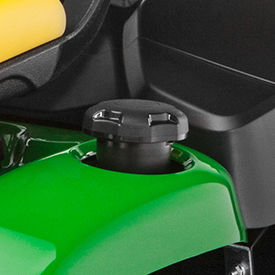 Large fuel-fill opening
Large fuel-fill opening
Large, 3-in. (7.6-cm) diameter fuel tank filler opening makes adding fuel easy:
- Located on the left fender
- Helps eliminate spillage
- 2-U.S. gal. (7.6-L) capacity
- A low-fuel light is provided on the tractor dash to tell the operator when it is time to refuel.
42-in. (107-cm) Rear-Discharge Rear-Collect Mower Deck cuts clean
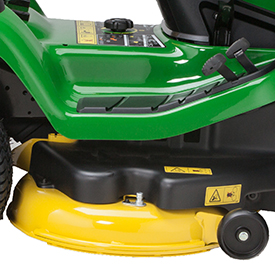 X350R 42-in. (107-cm) Mower Deck
X350R 42-in. (107-cm) Mower Deck
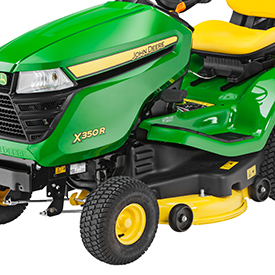 X350R 42-in. (107-cm) Mower Deck
X350R 42-in. (107-cm) Mower Deck
The innovative design of the 42-in. (107-cm) Edge™ Rear-Discharge Deck combines the best features for reliability and superior performance when mowing, collecting, and mulching grass and leaves:
- The mower deck is stamped from 11-gauge, 0.12-in. (3-mm) steel to provide smooth contours for a quality appearance and excellent performance.
- Easy to install or remove mulch plug is included as standard equipment.
- The included AM147289 blades provide optimal collection/rear discharge and good mulching results in many conditions. For optimal mulching, AM140332 mulching blades are available.
- With no side-discharge chute, the mower can trim on either side for mowing efficiency and convenience.
- A smaller storage area requirement is an additional benefit.
- A standard V-belt and non-timed blade design gives superior reliability and trouble-free operation.
- Offset mower blades permit blade overlap with the use of a standard V-belt drive.
- The blades cut cleanly without being able to contact each other.
- Cut-height increments of 0.25 in. (0.64 cm) allow for operating the mower at the optimum cutting height.
- An Exact Adjust deck-leveling system is provided to make keeping the deck properly adjusted easy.
The mower deck is contoured and free of obstructions to ensure optimum cutting and bagging performance:
- Grass clippings flow smoothly around the deck and up the chute into the hopper.
- Clipping buildup is minimized to ensure continued high-performance and easy cleanup.
- Special discharge blades (standard equipment) have a large wing to propel grass clippings up the chute and into the hopper.
- Mower fills and packs the 8.5-bu (300-L) hopper with a large volume of grass clippings and/or leaves.
Standard mulch plug
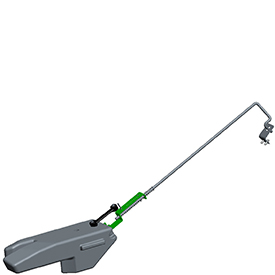 Standard mulch plug
Standard mulch plug
Mulch plug easily installs in place of hopper:
- A mulch plug is included with the model year 2017 and later X350R as standard equipment (serial number 20,001-).
- Mulch plug is ideal for times when collecting grass clippings and leaves is not desired. The rear hopper can be easily removed and the mulch plug installed.
- Plug closes off opening on bottom of deck so material cannot enter the chute.
- The included AM147289 blades provide optimal bagging and rear discharge performance and good mulching results in many conditions.
- For optimal mulching, AM140332 mulching blades are available.
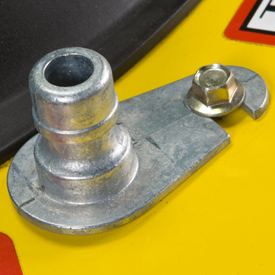 Wash port
Wash port
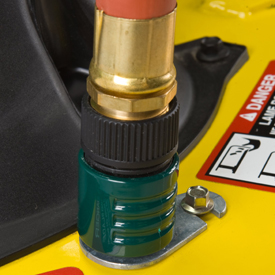 Hose-end adapter for use with wash port
Hose-end adapter for use with wash port
A wash port is provided on the mower deck. It can be used to supply water to the underside of the deck so it can be easily cleaned after use:
- The wash ports is designed for hose quick-connect fitting.
- Connect hose to the wash port and operate the mower to clean.
- Using the wash port cleans bottom of deck and chute.
- The wash port works best if used immediately after the mowing job is completed.
- Use of the wash port prevents buildup of material from affecting performance the next time the mower is used.
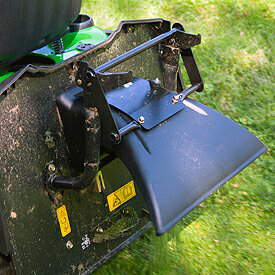 Optional rear deflector
Optional rear deflector
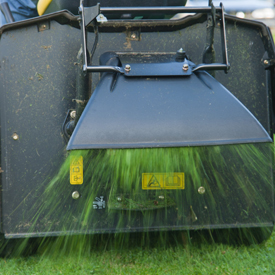 Optional rear deflector in operation
Optional rear deflector in operation
Optional rear deflector (BM25065) easily installs in place of hopper:
- No tools required for installation
- Deflects clippings in an even pattern behind the tractor
Rear hopper has large capacity and is easy to empty
 Hopper easily emptied from operator seat
Hopper easily emptied from operator seat
 Durable 8.5-bu (300-L) hopper empties completely
Durable 8.5-bu (300-L) hopper empties completely
The innovative design of the rear hopper sets a high standard for collecting systems:
- Hopper is constructed of durable fabric for flexibility, where needed.
Hopper shipping
 Hopper is nested in tractor for efficient shipping
Hopper is nested in tractor for efficient shipping
 Large-capacity hopper
Large-capacity hopper
The rear hopper is shipped in the returnable shipping crate with the tractor:
- Minimizes shipping cost
- No extra carton material of which to dispose
The hopper is made of durable materials and sealed to keep dust away from the operator.
Four-year or 300-hour bumper-to-bumper warranty is standard
An exclusive 4-year or 300-hour (whichever comes first), single-source, bumper-to-bumper warranty* is standard for all John Deere X300 Series Tractors.
- The warranty is hassle free, with one company handling all of the paperwork.
- Premium features of X300 Series Tractors allow for this longer warranty period, with more coverage than comparable tractors.
*Term limited to years or hours used, whichever comes first, and varies by model. See the LIMITED WARRANTY FOR NEW JOHN DEERE TURF AND UTILITY EQUIPMENT at JohnDeere.com or JohnDeere.ca/TUWarranty for details.
Snow removal is a strength of lawn tractors
 44-in. (112-cm) Front Blade
44-in. (112-cm) Front Blade
 Snow blower, weather enclosure, and chains on an X300 Series Tractor
Snow blower, weather enclosure, and chains on an X300 Series Tractor
An advantage of lawn tractors is their ability to use equipment for snow removal. Lawn tractor owners can add a John Deere snow blower or front blade to make quick work of moving snow whenever the need arises. Weather enclosure and tire-chain attachments add comfort and performance.
Equipment available for snow removal includes:
- 44-in. (112-cm) Snow Blower
- 44-in. (112-cm) Front Blade
- 48-in. (122-cm) Front Blade (X394 Tractor only)
- Tire chains or TerraGrip traction belts
- Weather enclosure (available for all X300 Series, except the X350R)
- Weights
Steering is low-effort sector and pinion system
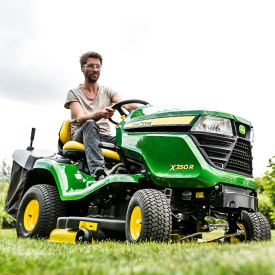 High-quality steering system for easy operation
High-quality steering system for easy operation
A heavy-duty sector and pinion steering system with quality bearings provides easy and precise control for the life of the tractor:
- Tight turning radius of 16.5 in. (42 cm) provides good maneuverability.
- Easy steering promotes mowing efficiency and operator comfort.
Easy steering
Easy steering is important to give the operator an enjoyable mowing experience:
-
Large, 14-in. (36-cm) diameter steering wheel gives good leverage for easy turns.
-
Larger sector gear gives improved (increased) steering ratio.
-
Higher steering ratio results in less effort to turn the wheel.
-
- Ball-joints on both ends of the steering tie rod and drag link maintain accurate steering longer.
-
Long steering drag link improves mechanical advantage of the steering system though the full range of motion.
- Sector gear pivots on a shaft rather than a bushing.
- This ensures proper gear mesh and eliminates binding to result in easier steering.
- Greaseable front steering spindles improves wear over time.
Integrated hydrostatic transaxle is efficient
 Kanzaki® K46 transaxle
Kanzaki® K46 transaxle
The Tuff Torq® hydrostatic transaxle encloses the hydrostatic pump and motor rotator groups in the same housing with the differential and axle housings:
- This very efficient design reduces the number of sealing surfaces and minimizes potential for leakage.
- The transaxle is essentially the same as the one used in the X350 Tractor; however, it is reversed and the drive linkage is unique, to work with the rear-discharge system.
When combined with the foot controls, the hydrostatic transmission functions similarly to an automatic transmission in an automobile, so the term automatic is often used to describe it:
- Use of the latest valve designs has significantly reduced the sound level.
- Large pump and motor rotating groups ensure efficient operation and long life.
Freewheeling valve
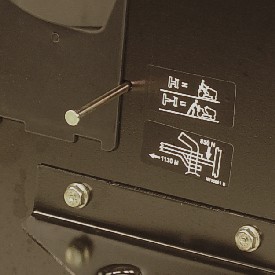 Convenient freewheeling valve
Convenient freewheeling valve
The freewheeling valve control is located near the tractor rear hitch plate for good visibility and easy operation.
Kanzaki and Tuff Torq are trademarks of Kanzaki Kokyukoki Manufacturing Company.
Controls and display functions are easy to identify and convenient to use
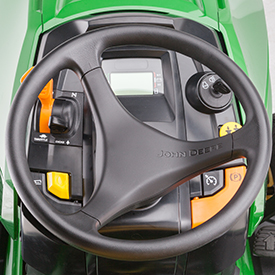 Operator station
Operator station
 Close-up of display
Close-up of display
The contoured dash has clean, attractive styling and ergonomic controls for easy use:
- Controls are color coded and labeled with English words for easy identification by the operator.
- Controls are logically placed and easy to reach.
- The power take-off (PTO) switch allows the operator to get fingers underneath it, like a T-handle, to pull up for easy activation.
- The reverse implement option (RIO) switch is a yellow button.
- The latch control on foot-lift models and hydraulic-lift control on power-lift models and the park brake latch are pivot levers for low effort.
- Cruise control activation is handled by an automotive-style button.
- Separate engine speed and choke controls make starting and warming up the engine easier in cold weather.
- The choke lever is spring loaded to eliminate the chance the tractor will be unintentionally operated with the choke partially closed.
Display panel
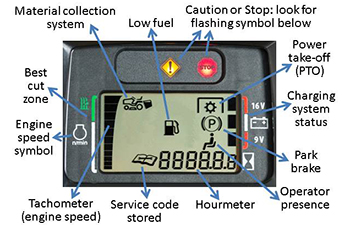 X350R display panel with indicators identified
X350R display panel with indicators identified
Display has the look and feel of a modern automobile. A power-up sequence cycles lights and gauges to indicate they are working:
- Display features dark-cockpit design to minimize operator distractions.
- Display is back lit for night visibility.
- Night visibility is especially useful with snow blower use.
- When the hopper is full, the hopper-full light comes on and a buzzer will sound. The operator will need to manually shut off the PTO.
- Hour meter makes it easy to tell when oil changes and other maintenance should be performed.
- Low-fuel light provides the operator with a noticeable warning when low on fuel.
- A tachometer graphically displays engine speed.
- Target-zone graphics inform the operator of the engine speed range to use for best cut quality.
- An indicator tells the operator when the PTO is operating.
- Bright caution and stop lights capture the operator's attention when important information is on the instrument cluster.
- Damage can be prevented and repair costs reduced by addressing problems early.
- Operators are advised of what the problem is if they attempt to operate the mower with unsatisfied PTO, seat, or park brake interlocks.
- The indicators are also useful to identify the reasons the PTO or engine may have shut off when an interlock is unsatisfied.
- Operators are advised if battery voltage is low, normal, or excessive.
- The service indicator light illuminates to indicate a diagnostic error code is stored.
- On-board diagnostics provides trouble codes for use by trained technicians.
- For example, a technician will be able to test switch functionality and circuit continuity without tools.
Twin Touch™ foot control
 Twin Touch foot control
Twin Touch foot control
 Cruise control
Cruise control
Twin Touch foot pedals control the speed and direction of travel:
- Automotive-type accelerator control ensures easy operation.
- Operator can change direction without lifting foot off the platform.
- Large pedal surface gives superior operator comfort.
Cruise control
Cruise control is standard equipment:
- To engage, push the cruise-control button and hold until the foot is removed from the forward pedal.
- For emergency stop, the cruise control can be released by pushing on the brake pedal or the forward pedal.
Mower deck height adjustment
 Conveniently-located deck height adjustment knob
Conveniently-located deck height adjustment knob
 Onboard mower adjusting gauge and wrench
Onboard mower adjusting gauge and wrench
Rotary dial knob makes adjusting mower cut height quick and easy:
- Provides mower cut heights in 0.25-in. (6.4-cm) increments from 1 in. (2.5 cm) to 3.5 in. (8.9 cm)
- Mower deck returns to same preset height each time it is lowered
 Storage tray under tractor seat
Storage tray under tractor seat
 Exact Adjust tool used to level mower deck
Exact Adjust tool used to level mower deck
Storage for the onboard deck-leveling gauge and the Exact Adjust tool is provided in the storage tray under the tractor’s seat.
- Exact Adjust ports allow for easy and accurate leveling of the mower deck for optimum mowing performance
 Deck-leveling gauge placed under deck
Deck-leveling gauge placed under deck
Foot-pedal lift system
 Foot-pedal lift system
Foot-pedal lift system
Pushing with the foot to raise the mower or implement is less strenuous for many operators:
- The easy-to-use raised position lock operates similarly to the park brake lock.
- The foot pedal is out of the way and not likely to catch on bushes and tree limbs when mowing.
- The mower deck returns to same preset height each time it is lowered.
- A spring is provided to minimize lift effort.
- An optional BM24810 supplemental lift-assist spring kit (X350R) is required for snow blower use on the X350R.
- The mower will not be inadvertently locked in the raised position when mowing through ditches.
- When installing or removing a mower or front equipment raised by the foot lift system, spring tension may be removed from the connection points by pulling rearward on the lift pedal and raising the lift latch to hold the pedal in the rearward position.
Parking brake control
 Parking brake
Parking brake
Depressing brake pedal applies internal wet disk brakes (increased durability and longer life) for safe stopping.
Parking brake control is conveniently located for easy access; holds brake pedal securely in locked position.
Electric power take-off (PTO) clutch is easy and convenient to use
 Electric PTO switch
Electric PTO switch
The heavy-duty electric PTO clutch is operated with a convenient dash-mounted switch.
Heavy-duty PTO clutch
 PTO clutch
PTO clutch
The PTO clutch is designed to operate through many on/off cycles.
Reverse implement option (RIO) and interlock switches
 Reverse implement switch
Reverse implement switch
Using RIO
CAUTION: Children or bystanders may be injured by rotating blades. Before traveling forward or rearward:
- Carefully check the area around the machine.
- Disengage the mower before backing up.
NOTE: Operating the mower while backing up is strongly discouraged. RIO should be used only when operating another attachment or when the operator deems it necessary to reposition the machine with the mower engaged.
- Stop forward travel. Allow attachment to run.
- Look down and behind the machine to be sure that there are no bystanders.
- Push and hold in the reverse implement switch while depressing the reverse pedal slightly.
NOTE: If the attachment stops while positioning the machine, return the mower engagement (PTO) switch to off position. Repeat this procedure from the beginning. - Release the reverse implement switch and reposition the machine as the machine begins to move rearward.
- Resume forward travel. The attachment should continue operating.
- Repeat procedure to position the machine again.
Interlock switches
 Switch senses if hopper is installed
Switch senses if hopper is installed
A switch senses if the hopper is installed. If the hopper is not installed and the PTO switch is actuated, the PTO will not operate.
A brake interlock switch is provided so the tractor will not start unless the brake is depressed or the parking brake set.
A tractor seat switch will turn off the PTO if the operator leaves the tractor seat; it will also shut-down the engine if the park brake is not set and the operator leaves the seat.
Either the operator needs to be in the seat or the hopper or deflector installed for the engine to run.
Frame is reliable heavy-duty welded steel
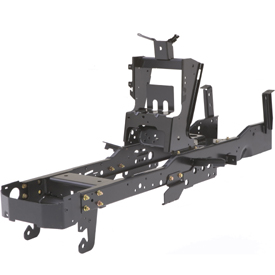 Heavy-duty frame
Heavy-duty frame
 Steel front-side of hopper bolted to frame
Steel front-side of hopper bolted to frame
The frame is made of heavy formed and welded steel, reinforced in critical areas for even greater strength.
The steel front side of the hopper is bolted to the rear of the tractor frame:
- Reinforces the frame and provides a solid support for the hopper
- Frame formed from 12-gauge, 0.105-in. (2.66-mm) thick material
- Standard front bumper formed from 9-gauge, 0.15-in. (3.8-mm) steel to complete the frame assembly
- An optional front weight bracket/bumper is available for adding Quik-Tatch weights.
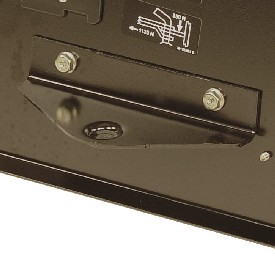 Standard rear hitch for tow-behind equipment
Standard rear hitch for tow-behind equipment
A standard rear hitch is included for pulling tow-behind equipment. Simply lift off the hopper and the hitch is ready to use.
Front axle and wheel spindles are heavy-duty
 Cast-iron front axle
Cast-iron front axle
Front axle is made of nodular cast iron:
- Cast-iron front axle is strong and shock-resistant.
- Cast iron will not yield under heavy loads or impact.
A replaceable bushing is used at axle mounting:
- The bushing provides excellent wear resistance.
- Grease fittings at each spindle are easy to service.
A replaceable bushing is used at axle mounting:
 Steering spindle
Steering spindle
Front steering spindle diameter is 0.75 in. (19 mm) for strength and long life:
- Have strength to handle heavy implements
- Provide long life at bearing surfaces
- Use sealed precision bearings in front wheels
Modern styling is eye-appealing and functional
 Attractive styling
Attractive styling
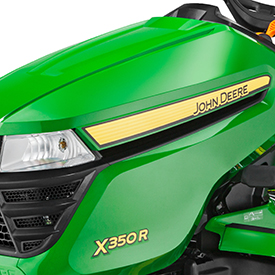 Hood air-intake louvers
Hood air-intake louvers
Smooth, rounded contours present a modern, stylish appearance:
- Hood styling incorporates efficient full-length air-intake louvers on each side, rather than on the top, for cooler engine operation and lower operator station sound levels.
- Hot air is vented out the front grille, away from the operator.
- The fully enclosed hood is made of molded-in-color material.
- Reduces sound
- Will not rust or dent
- Distinctive grille and large, one-piece fender deck complete the styling package.
Two high-quality headlights give excellent visibility
 Optimum lighting pattern
Optimum lighting pattern
Headlights are standard equipment on all models:
- Two 27-W bulbs provide excellent lighting for good visibility during evening operation.
- A headlight position on the ignition switch makes it easy to operate the headlights.
- The headlights are designed to provide an optimum lighting pattern for mowing and snow removal.
Operator station is comfortable and convenient
 Operator station
Operator station
 Operator station
Operator station
The operator station is designed for operator comfort and ease of using controls:
- A large, 14-in. (36-cm) diameter steering wheel is comfortable to use and minimizes steering effort.
- Full-length foot mats provide comfort for the operator and protect the footrest area.
Comfortable seat
 Comfortable open-back seat
Comfortable open-back seat

An open-back 15-in. (38-cm) high-back seat provides a comfortable, smooth ride and good support for the operator:
- Seat travel of 7 in. (18 cm) with 15 positions allows the operator to be seated comfortably and easily operate the controls.
- Seat can be easily adjusted fore and aft by the operator while sitting on the seat.
- Open-back design allows air circulation to keep the operator's back cool and dry for a more comfortable ride.
- Grasp at the top of the seat is conveniently located for use when tilting the seat up to protect it from the weather.
Seat suspension
 Seat suspension
Seat suspension

The seat suspension is adjustable, without tools, for the weight of the operator:
- Springs are adjustable fore and aft to any of three positions.
- No tools require
- Allows fine-tuning of the suspension for the operator's weight
- Back position for more support for heavier operators
- Tool tray is designed into the seat base.
- Can be used to store gloves, small tools, etc.
- Provides storage location for Exact Adjust tool and deck-leveling gauge (tool and depth-leveling gauge not shown in photo)
Cup holder
 Cup holder and tool tray on fender
Cup holder and tool tray on fender
A cup holder and tool tray are located on the fender for operator convenience:
- The cup holder holds a variety of container sizes.
- Tool tray provides convenient storage.
- Cup holder and tool tray are constructed of durable acrylonitrile butadiene styrene (ABS) plastic.
Removable plug for optional 12-V outlet
 Location for optional 12-V outlet
Location for optional 12-V outlet
A removable plug on the console, in front of the operator, provides a convenient location for the optional 12-V outlet and makes installation easy.
- Convenient for plugging in cell phone charger and other electric devices
- Can be used to operate electric rear equipment, such as a sprayer or spreader
12-V fast connector
 Illustration of fast connector location
Illustration of fast connector location
A mid-vehicle, 12-V fast connector, located under the tractor’s fuse box, is included as standard equipment to reduce initial installation time for some attachments that operate on 12-V power from the tractor:
- The four-cavity connector includes battery, ground, and key switch terminals and is turned on and off with the ignition switch.
Serviceability convenience is built in
 One-piece hood is easy to open
One-piece hood is easy to open
 Service interval decal located under hood
Service interval decal located under hood
The one-piece hood opens easily to permit checking and servicing the engine:
- Important service points are located within easy reach.
- A service-interval decal is provided inside the tractor hood for convenience when servicing the tractor.
- The high-quality engine used in the X350R does not require an 8-hour oil and filter change because improvements in the manufacturing process and quality of parts, components, and oils have eliminated the need for the short interval oil change requirement.
 Easy-to-service engine fuel and oil filters
Easy-to-service engine fuel and oil filters
The engine fuel and oil filters, the oil check/fill tube, and the oil drain tube are exposed for serviceability when the hood is opened.
Hopper adjustment and removal
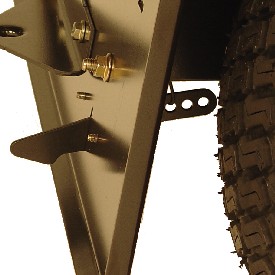 Adjustable hopper latch
Adjustable hopper latch
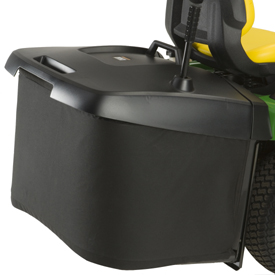 Hopper is easily removed and reinstalled
Hopper is easily removed and reinstalled
Hopper latch is easily adjustable for operator preference and conditions:
-
Spring can be located in any of three holes.
-
More latching effort is required for hilly or rough operating conditions.
The hopper is easily removed by using the rear handle to raise the back end of the hopper 25 degrees, or about 5 in. (13 cm), and then using both handles to lift the hopper vertically out of the notches:
-
No tools are required.
-
There is nothing to disconnect.
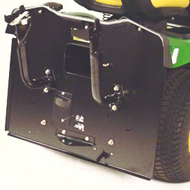 Hopper removed
Hopper removed
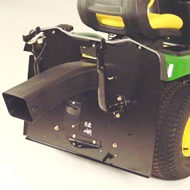 Chute shown pulled out part way
Chute shown pulled out part way
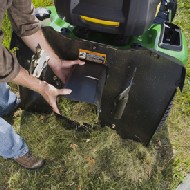 Chute is easily removed and cleaned if necessary
Chute is easily removed and cleaned if necessary
The chute can be easily pulled out and removed:
-
Chute must be at least partially pulled out before removing the mower deck.
-
Removing the chute makes cleaning it easy.
Exact Adjust ports and onboard deck-leveling tools make precise deck adjustments easy
 Deck-leveling gauge and hex adjusting tool stored under tractor seat
Deck-leveling gauge and hex adjusting tool stored under tractor seat
 Exact Adjust access holes
Exact Adjust access holes
A mower deck must be level side-to-side and properly adjusted front-to-rear to give the best cutting performance. A removable onboard deck-leveling gauge and a hex-key tool are provided to make adjustment easy. They are securely stored under the tractor seat.
Exact Adjust leveling ports are provided on each side of the operator platform above the mower-level adjusting bolts. With the hex-shaped tool, they provide convenient access to allow quick and easy adjustment of the mower for the best-cut quality of cut.
The Exact Adjust feature is standard on all Select Series™ X300 and X500 Tractors:
- There is no need to reach under the fender deck while making the mower-level adjustment.
- Onboard deck-leveling gauge, Exact Adjust ports, and the hex tool work together.
- Level the mower deck side to side
- Set the correct amount of rake (front-to-back deck orientation)
- Calibrate the cutting height to the cut-height adjusting knob setting
- Exact Adjust simplifies leveling the mower deck if equipped with a Power Flow™ blower.
- To give the best cut, mower level should be adjusted if alternately mowing with and without blower installed. The Exact Adjust feature makes this easy.
 Deck-leveling tool placed under deck
Deck-leveling tool placed under deck
 Using included ball-hex tool to level mower deck
Using included ball-hex tool to level mower deck
Consult the operator's manual for the correct adjusting procedures for each tractor model. Basic adjusting steps to properly level the mower deck include:
- Park the tractor on a level surface.
- Inflate tires to the correct pressure.
- Consult the label for the cutting-height knob that is located on the console of the machine. This label shows deck-leveling position and location of deck-leveling adjustment points.
 Cut height adjusting knob
Cut height adjusting knob
- Set mower cutting-height knob to the correct deck-leveling position.
- For X300 models, use position 2.75
- For all other models, use position 2.5
- Adjust mower wheels as necessary so they do not contact the ground surface.
- Remove the onboard deck-leveling gauge that is located under the seat.
- Using the Exact Adjust ports and tool, adjust mower deck side-to-side level so the deck-leveling gauge just slips under the left and right lower deck rim at the designated adjustment points. The location of adjustment points will vary slightly between decks.
- Left- and right-rear adjustment points are under the deck rim near the rear mower wheels, if equipped.
- Adjust mower deck front-to-back level, if necessary.
- Loosen rear nuts equally on each side of front lift rod.
- Turn front nut equally on each side clockwise to raise front of mower or counterclockwise to lower it until gauge just slips under the front adjustment point.
- Tighten rear nuts after adjustment is complete.
- Return the gauge to its storage position.
NOTE: The adjusting tool supplied with the tractor is an 8-mm ball-hex key, part number M162737. The rounded end allows for some misalignment with the bolt as the deck is adjusted.
The MowerPlus™ app helps maintain the tractor and lawn
 MowerPlus app screen
MowerPlus app screen
 MowerPlus app maintenance screen
MowerPlus app maintenance screen
Keep a John Deere riding lawn mower running its best and know how it mows with the John Deere MowerPlus app. Simply scan the lawn tractor’s barcode to get custom information. The app helps determine the best time to mow, communicates expert pre-mow tips, offers maintenance reminders, and provides walk-through guides.
Look for the MowerPlus app on the mobile device’s app store.
The app supports residential lawn equipment such as 100 Series, S240, X300, X500, X700, Z200 through Z600, and many similarly-sized older products. It does not presently support tractor models numbered 1000 and larger, such as 1025R.
NOTE: Some product image variation may exist.
Also available is the John Deere MowerPlus smart connector (sold separately).
 Smart connector
Smart connector
The John Deere MowerPlus smart connector wirelessly links a Select Series™ X300 or X500 Tractor to the MowerPlus app on a mobile device. The smart connector transmits engine usage to the app, making it easy to track maintenance intervals. It also transmits the fuel level to the app—when thinking ahead about Saturday morning mowing, the operator can make sure the tractor is fueled and ready to go.
Features
Engine is smooth-running and reliable V-twin air-cooled design
 18.5-hp (13.8-kW) V-twin engine
18.5-hp (13.8-kW) V-twin engine

The tractor is powered by a John Deere iTorque™ power system, a combination of engine features and an exclusive hood design that provides superior lugging ability, even cooling, and durability.
Key engine features include:
- 18.5 hp (13.8 kW)
- Large 603-cc displacement
- V-twin air-cooled design that provides smooth, quiet power
- Quality features include:
- Cast-iron cylinder liners
- Overhead valves
- Full-pressure lubrication
- Replaceable oil filter
- Dual-stage air cleaner
- V-twin design:
- Excellent power and performance
- Easy starts
- Smooth operation
Flywheel alternator
A flywheel alternator provides plenty of capacity to quickly recharge the battery and power electrical equipment, such as lights or a sprayer:
- 15-amp capacity
- Regulated to keep the battery at full charge without risk of overcharging
Fuel tank has large, 3.3-U.S. gal. (12.5-L) capacity
 Fuel tank
Fuel tank
 Electronic fuel gauge
Electronic fuel gauge
Large fuel tank and convenient fuel gauge minimize the number of stops for fuel and chance of running out of fuel:
- Fuel tank has a large, 3.3-U.S. gal. (12.5-L) capacity for more hours of operation between refills.
- Large, 3-in. (7.6-cm) diameter fuel tank filler opening makes adding fuel easy.
- Located on the left fender
- Helps eliminate spillage
- Electronic fuel gauge on the dash display allows the operator to easily monitor the amount of fuel in the tank.
The 48-in. (122-cm) Accel Deep™ (48A) Mower Deck cuts clean and is versatile
 X394 with Accel Deep 48A Mower
X394 with Accel Deep 48A Mower
 Accel Deep 48A Mower
Accel Deep 48A Mower
The 48-in. (122-cm) Accel Deep Deck uses the latest in three-spindle mowing technology to raise performance to a higher level:
- 10-gauge, 0.135-in. (3.4-mm) deck stamping for long life
- Deep, flat-top deck design to handle a large volume of material at faster mowing speeds
- Gives excellent cut quality and uniform discharge
- Easy to keep clean on top of and under the deck
- Resilient four-point mounting system suspends mower from tractor for a smooth and level cut
- Wide mower wheels easily adjusted just above ground level to help prevent scalping
- 0.25-in. (6.4-mm) cut-height increments allow mower to be set at the desired cut height
- Onboard deck-leveling system makes keeping mower properly adjusted easy
- Compatible with optional MulchControl™ mulching system
- Compatible with high-performance Power Flow™ material collection systems
- For use on X330, X350, X354, X370, X380, X384, X390, X394, X570, X580, X584, and model year 2016 X590 Tractors
The 48-in. (122-cm) Accel Deep Mower Deck is a stamped-steel, deep, flat-top design that delivers excellent cut quality, productivity, cleanliness, durability, and versatility. Optimal performance and dispersion of clippings is provided, even at faster mowing speeds:
- 4.83-in. (12.3-cm) depth throughout the entire deck shell for optimum mowing, mulching, and bagging performance
- Optional lever-action or electric one-touch MulchControl attachment provides superior mulching performance and versatility.
- Stamped-steel design eliminates sharp edges and corners where material can build up and diminish mowing performance
- Mower deck is suspended from the vehicle for a smooth and level cut
- Adjustable mower wheels, positioned just above ground level, help reduce scalping
Excellent cut quality
 48A Mower top (similar mower from X700 Series Tractor shown)
48A Mower top (similar mower from X700 Series Tractor shown)
 48A Mower underside (similar mower from X700 Series Tractor shown)
48A Mower underside (similar mower from X700 Series Tractor shown)
Deep mower-deck stamping gives excellent cut quality. It allows the cut and suspended material room to exit the deck without getting recut:
- Reducing the amount of re-cutting enables more power to be used to cut incoming grass, which greatly improves mower capacity.
- Helps maintain excellent cut quality at faster mowing speeds
- Clean flow of material out of discharge area prevents cut material from interfering with cutting the incoming grass, making it possible for the blades to cut incoming material cleanly.
- Even in mulching mode, cut evenness is improved compared to other designs because the additional depth allows for continuous circulation, optimal re-cutting, and an even distribution of clippings.
Productivity - getting the job done fast
 Right side of Accel Deep 48A Mower Deck
Right side of Accel Deep 48A Mower Deck
Deep mower-deck stamping gives high productivity, which gets the job done fast. It allows the cut and suspended material room to exit the deck quickly, reducing the amount of re-cutting so more power is available to process incoming grass:
- Greatly improves mowers capacity to maintain excellent mowing performance in difficult mowing conditions and at higher speeds
Large discharge opening is both high and wide to handle more material:
- Gives a smooth, even discharge of clippings at all mowing speeds
- Reduces the chance of plugging, especially important when operating in wet, thick, or dense grass and when bagging
- The 48A Power Flow blower has an inlet housing with over 50 percent greater area than the 48X Power Flow blower used on previous machines.
Cleanliness - for the mower and the operator
 Accel Deep 48A Mower Deck
Accel Deep 48A Mower Deck
 Accel Deep 48A Mower Deck
Accel Deep 48A Mower Deck
The flat-top shape of the deck stamping is optimal for keeping itself and the operator clean:
- There are few places to catch and hold material on top and underneath the deck.
- Top of deck stays cleaner, reducing time and effort needed for cleaning and service
- Underside of deck is self-cleaning to maintain optimum performance without buildup of material to interfere with the flow of air and clippings
- Less need to clean and remove buildup of material from underside deck
- The depth of the Accel Deep mower deck minimizes the amount of material that escapes from the front of the deck:
- Limited amount of material to drift onto the operator and mower deck
- Even for material discharged out the chute, less re-cutting results in larger pieces that are less likely to end up on the operator
- Mulching prevents the discharge of material completely and the MulchControl attachment makes mulching a practical solution for most mowing situations.
Cleaning a mower deck, both top and bottom, is one of the most frequent maintenance activities:
- The flat-top design reduces places for material to build up and makes material that does collect easy to remove.
 Mower wash port
Mower wash port
 Mower wash port with hose connector
Mower wash port with hose connector
A wash port is provided to make cleaning the underside of the mower deck easy.
- Hose connector is included with the mower deck.
Superior durability is designed in
 Spindle pocket with flip-up cover
Spindle pocket with flip-up cover
 Easy-to-adjust mower wheel and mower side reinforcement
Easy-to-adjust mower wheel and mower side reinforcement
The 48A Mower Deck has strong spindle pockets, to keep the blades aligned, even after years of tough service:
- Ribs in the deck shell add strength where it is needed.
- The 48A has a 23 percent heavier overall weight than the Edge™ Xtra 48-in. (122-cm) mower deck used on previous machines.
Mower wheels are heavy duty:
- Provides greater strength and durability for longer, trouble-free life.
- Setting wheels to the correct height for the cutting height quick and easy.
Low-tension belt-drive design reduces the side load on engine lower bearings and mower deck bearings for longer life.
The 48A Mower Deck features a 5/8-in. (16-mm) diameter solid-steel rod side bumper that provides extra strength and protection.
Dual-stage E-coat and powder-paint coatings provide extra protection from rust.
Versatility - easy to change between side discharge, mulch, and bagging modes
The 48A Mower is designed for maximum versatility, providing the greatest ease in changing from one mower discharge mode to another:
- With an optional MulchControl attachment installed (along with the special mulching blades), changing from side-discharging to mulching or vice versa is done with the simple flip of a lever or push of an electric switch.
- The Power Flow rear bagger can be used with the MulchControl attachment and blades installed by simply using the MulchControl lever or electric one-touch switch to move the mulch baffle to the side-discharge position.
MulchControl option
A lever-action or electric one-touch MulchControl attachment for the 48A Mower Deck makes mulching more practical for many mowing situations because it not only does an excellent job of mulching but it also allows the mower to be easily converted for times when it is more desirable to side discharge or collect the lawn material. Advantages of mulching grass clippings include:
- A beautiful looking lawn
- Grass clippings not blown onto the operator, driveways, or flower beds
- Less fertilizer use
- Elimination of the effort needed to dispose of clippings
How MulchControl works
 MulchControl baffle open
MulchControl baffle open
 MulchControl baffle closed
MulchControl baffle closed
MulchControl is an innovative, simple design that is easy to use and maintain:
- The MulchControl attachment includes baffles to control the flow of material under the deck.
- The MulchControl baffle, or divider, between the left and middle spindles is about half way down. The height is designed to balance the mulching and side-discharge modes.
- When the MulchControl baffle is open, the divider between the left and middle spindles passes a portion of the material to the discharge opening, along with the material from the middle and right spindle areas.
- When the MulchControl baffle is closed, the material stays within the deck and gets chopped into mulch and deposited in the turf.
 MulchControl handle
MulchControl handle
 Electric one-touch MulchControl switch
Electric one-touch MulchControl switch
- For the lever-action MulchControl attachment, a handle on top of the mower deck is used to engage or disengage mulch mode.
- The operator is required to get off of the tractor in order to engage or disengage mulch mode with the lever-action system.
- For the electric one-touch MulchControl attachment, a switch on the tractor dash is used to engage or disengage mulch mode.
- Changing from mulch mode to side discharge mode or vice versa takes only a few seconds.
MulchControl is well-suited to the following mowing situations:
- Usually mulch, but side discharge when grass gets too long
- Usually side-discharge, but would like to be able to close the chute to control clippings
- Always mulch a main lawn, but often side discharge secondary lawns
- Bag clippings, but want to go farther before emptying bags
MulchControl puts the operator in control of the clippings. The operator can have all the benefits of mulching with the ability to easily change to side discharging or bagging when needed.
While in the side-discharge mode, MulchControl will still mulch about one third of the material. Therefore, the side-discharge mode is essentially a partial-mulch mode. This can be an advantage when side discharging or bagging, as it helps to reduce the amount of material being discharged. Other times this could work as a disadvantage:
- When cutting strong southern grasses, such as Zoysia and Bermuda
- When cutting in wet, high-growth conditions, such as those found in the Pacific Northwest United States
- When optimum bagging and lawn clean-up is desired
7-bu (247-L) Power Flow rear bagger
 Optional rear bagger
Optional rear bagger
 Power Flow blower
Power Flow blower
An optional 7-bu (247-L) rear bagger material collection system (MCS) is available. It provides an efficient means of collecting grass clippings and leaves:
- The Power Flow blower and chute are easy to install. The Power Flow blower swings out for easy cleanout and cleanup.
- The hopper design provides modern styling, great bagging performance, cleaner operation, and easy-to-empty bags:
- 7-bu (247-L) capacity
- Easy-to-attach Power Flow blower (ordered separately)
- Easy-to-attach chute (ordered separately)
- Air exhaust duct
- Convenient spring-latch
- Airflow fill indicator
- Quik-Tatch mounting
- Sealed hopper top
- Loose-knit bags available
Larger 14-bu (493-L) and 19-bu (670-L) MCS are available, in addition to the 7-bu (247-L) MCS, for specific X300 and X500 Series Tractor models.
Four-year or 300-hour bumper-to-bumper warranty is standard
An exclusive 4-year or 300-hour (whichever comes first), single-source, bumper-to-bumper warranty* is standard for all John Deere X300 Series Tractors.
- The warranty is hassle free, with one company handling all of the paperwork.
- Premium features of X300 Series Tractors allow for this longer warranty period, with more coverage than comparable tractors.
*Term limited to years or hours used, whichever comes first, and varies by model. See the LIMITED WARRANTY FOR NEW JOHN DEERE TURF AND UTILITY EQUIPMENT at JohnDeere.com or JohnDeere.ca/TUWarranty for details.
Lever-action or electric one-touch MulchControl™ options are available for extra mowing convenience
 Lever-action MulchContol lever
Lever-action MulchContol lever
 Electric one-touch MulchControl switch
Electric one-touch MulchControl switch
Lever-action or electric one-touch MulchControl attachment is available for Accel Deep™ 42-in. (107-cm) (42A), 48-in. (122-cm) (48A), and 54-in. (137-cm) (54A) Mower Decks used on X300 and X500 Select Series™ Tractors.
MulchControl advantages and benefits
MulchControl enhances versatility and productivity. A mower deck equipped with MulchControl not only does an excellent job of mowing and mulching, but it can also be quickly converted from side discharging to mulching or vice versa:
- In mulch mode, it controls clippings dispersion in unwanted areas (driveways, landscape beds, near buildings, windows, parking lots, etc.).
- Reduces cleanup time needed to dispose of clippings.
- Reduces the amount of material entering a material collection system because, even in the side discharge mode, MulchControl will mulch about one third of the material due to the additional baffles under the mower deck and the unique design of the mulching blades.
Electric MulchControl has the additional advantage of being controlled from the tractor seat by a switch on the dash to operate an electric actuator that moves the baffle to close off the discharge area of the mower deck.
 Electric one-touch MulchControl switch
Electric one-touch MulchControl switch
 Electric one-touch MulchControl actuator
Electric one-touch MulchControl actuator
- Operators can convert between modes without interrupting the mowing process, making it practical to change between modes as conditions require.
- When approaching clean areas like driveways or flowerbeds where clippings would be undesirable
- When a breeze might blow clippings back onto the operator
- For side discharge mowing only the areas of the property where grass is too thick for mulching
- With 48A and 54A Mower Decks, for collecting only the areas of the property where grass is too tall or thick for mulching
- With 48A and 54A Mower Decks, the MulchControl baffle can be opened or closed with the Power Flow™ blower installed. The Power Flow blower will run without material when the baffle is closed.
- Models equipped with a 42A Mower Deck require a MulchControl baffle be removed to install the bagger chute; see 42A Mower Deck versatility explanation for more information.
- Changing from one mode to the other takes only a few seconds.
How MulchControl works
A mower equipped with a MulchControl attachment delivers unprecedented levels of productivity and versatility. The operator has the ability to quickly change between side discharging and mulching. A heavy-duty baffle opens and closes to convert the mower from side discharge mode to mulch mode or vice versa.
 MulchControl baffle open (similar mower deck shown)
MulchControl baffle open (similar mower deck shown)
 MulchControl baffle closed (similar mower deck shown)
MulchControl baffle closed (similar mower deck shown)
MulchControl is an innovative, simple design that is easy to use and maintain:
- The MulchControl attachment includes baffles to control the flow of material under the deck.
- When the MulchControl baffle is open, most of the material flows freely out the discharge deflector or into a material collection system.
- When the MulchControl baffle is closed, material stays within the deck and gets chopped into mulch and deposited in the turf.
MulchControl is well-suited to the following mowing situations:
- For operators who usually mulch, but side discharge when grass gets too long
- For operators who usually side discharge, but would like to be able to close the chute to control clippings in some areas
- For operators who always mulch a main lawn, but often side discharge secondary lawns
- For operators who collect clippings, but want to go farther before emptying the material collection system
MulchControl puts the operator in control of the clippings. The operator can have all the benefits of mulching with the ability to easily change to side discharging when desired.
Advantages of MulchControl include:
- Performance is improved.
- Mulching is beneficial because it returns the clippings to the ground as fertilizer, which promotes lawn growth.
- Clippings are much smaller, which allows them to fall into the grass and be removed from view.
- Unsightly grass clippings are not blown onto driveways or into flower beds.
- Fertilizer use is reduced and provides associated environmental benefits.
- Uptime is increased.
- Operators can convert quickly between modes, making it possible to change between mulching and side discharging as conditions require.
- Mulching heavy, thick material can significantly reduce mower productivity. The ability to switch from mulch to side discharge mode ensures productivity, especially in grass too tall or thick to mulch effectively.
- Cost of operation is reduced.
- Controlling clipping dispersion reduces cleanup time.
MulchControl limitations
While in the side discharge mode, MulchControl will still mulch about one third of the material. Therefore, the side discharge mode is essentially a partial mulch mode. This can be an advantage when side discharging or bagging, as it helps to reduce the amount of material being discharged. Other times this could work as a disadvantage:
- When cutting strong southern grasses, such as Zoysia and Bermuda
- When cutting in wet, high growth conditions, such as those found in the Pacific Northwest United States
- When optimum bagging and lawn cleanup is desired
- 42A Mower Deck requires a MulchControl baffle be removed to install the bagger chute
MulchControl compatibility
Each MulchControl attachment includes everything needed: baffles and mulch blades for all attachments, and the actuator, wiring, and switches for the electric one-touch attachments.
Lever-action MulchControl attachments
| Attachment number | Description | Applications |
| BM24794 | 42A MulchControl (lever action) | X300 Series Tractors, Z300 Series ZTrak™ Mowers |
| BM24993 | 48A MulchControl (lever action) | X300 and X500 Series Tractors, Z300 and Z500 Series ZTrak Mowers |
| BM24994 | 54A MulchControl (lever action) | X300 and X500 Series Tractors, Z300 and Z500 Series ZTrak Mowers |
Electric one-touch MulchControl attachments
| Attachment number | Description | Applications |
| BUC10164 | 42A electric one-touch MulchControl | X300 Series Tractors* |
| BUC10165 | 48A electric one-touch MulchControl | X300 and X500 Series Tractors* |
| BUC10166 | 54A electric one-touch MulchControl | X300 and X500 Series Tractors* |
* NOTE: Model year 2016-2017 X300 and X500 Series Tractors (X300 serial number 10,001-50,000 and X500 serial number 110,001-130,000) require replacing the tractor wiring harness and dash panel to use an electric MulchControl attachment.
Snow removal is a strength of lawn tractors
 44-in. (112-cm) Front Blade
44-in. (112-cm) Front Blade
 Snow blower, weather enclosure, and chains on an X300 Series Tractor
Snow blower, weather enclosure, and chains on an X300 Series Tractor
An advantage of lawn tractors is their ability to use equipment for snow removal. Lawn tractor owners can add a John Deere snow blower or front blade to make quick work of moving snow whenever the need arises. Weather enclosure and tire-chain attachments add comfort and performance.
Equipment available for snow removal includes:
- 44-in. (112-cm) Snow Blower
- 44-in. (112-cm) Front Blade
- 48-in. (122-cm) Front Blade (X394 Tractor only)
- Tire chains or TerraGrip traction belts
- Weather enclosure (available for all X300 Series, except the X350R)
- Weights
Steering is low-effort sector and pinion system
 Tight turning radius
Tight turning radius
 Designed for easy turns
Designed for easy turns
A heavy-duty sector and pinion steering system with quality bearings provides easy and precise control for the life of the tractor:
- Small, 16-in. (40.6-cm) turning radius provides excellent maneuverability
- Tight turning ability improves mowing efficiency
Easy steering
Easy steering is important for an enjoyable mowing experience:
-
Large, 14-in. (36-cm) diameter steering wheel for improved leverage
-
Large sector gear for improved (higher) steering ratio
-
A higher ratio equals lower steering effort
-
-
Dual drag links to help equalize the steering loads and reduce steering error
-
Ball joints on both ends of the steering tie rods for long life
-
Long steering arms to improve the mechanical advantage of the steering system through the full range of motion
- Sector gear that pivots on a shaft rather than a bushing to ensure proper gear mesh and eliminate binding
- Greaseable front steering spindles to reduce friction and improve wear over time
Integrated hydrostatic transaxle efficiently transmits power to wheels
 Kanzaki® K46 transaxle (X330, X350, X354) Kansaki K57 transaxle (X370)
Kanzaki® K46 transaxle (X330, X350, X354) Kansaki K57 transaxle (X370)
 Kanzaki K58 transaxle (X380, X384, X390, X394)
Kanzaki K58 transaxle (X380, X384, X390, X394)
The Tuff Torq® hydrostatic transaxle encloses the hydrostatic pump and motor rotator groups in the same housing with the differential and axle housings. This design is very efficient and reduces the number of sealing surfaces to minimize the potential for leakage.
Combined with the foot controls, the hydrostatic transmission functions similarly to that of an automatic transmission in an automobile, so the term automatic is often used to describe it:
- Use of the latest valve designs has significantly reduced the sound level.
- Large pump and motor rotating groups ensure long life and efficient operation.
Freewheeling valve
 Freewheeling valve
Freewheeling valve

A freewheeling valve control is conveniently located near the tractor rear hitch plate for good visibility and easy operation.
Kanzaki and Tuff Torq are trademarks of Kanzaki Kokyukoki Manufacturing Company.
Controls and display functions are easy to identify and convenient to use
 X394 Tractor mowing
X394 Tractor mowing
 Steering wheel and controls (switch turned on to show display)
Steering wheel and controls (switch turned on to show display)
Controls
The contoured dash has clean, attractive styling and ergonomic controls for easy use:
- Controls are color coded and labeled with English words for easy identification by the operator.
- Controls are logically placed and easy to reach.
- The power take-off (PTO) switch allows the operator to get fingers underneath it, like a T-handle, to pull up for easy activation.
- The reverse implement option (RIO) switch is a yellow button.
- The latch control on foot-lift models and hydraulic-lift control on power-lift models and the park brake latch are pivot levers for low effort.
- Cruise control activation is handled by an automotive-style button.
- Separate engine speed and choke controls make starting and warming up the engine easier in cold weather.
- The choke lever is spring loaded to eliminate the chance the tractor will be unintentionally operated with the choke partially closed.
- Functional design of the throttle and choke controls provides good appearance and a comfortable feel.
Display panel
 Display panel
Display panel
 Display panel illustration with descriptions
Display panel illustration with descriptions
Instrument display has the look and feel of a modern automobile. A power-up sequence cycles lights and gauges to indicate they are working:
- Display features dark-cockpit design to minimize operator distractions.
- Display is back lit for night visibility.
- Night visibility is especially useful with snow blower use.
- Hour meter makes it easy to tell when oil changes and other maintenance should be performed.
- Electronic fuel gauge provides real-time fuel level information.
- The X350R has a low fuel light, rather than a fuel gauge, to provide the operator with a noticeable warning when low on fuel.
- A tachometer graphically displays engine speed.
- Target-zone graphics inform the operator of the engine speed range to use for best cut quality.
- An indicator tells the operator when the PTO is operating.
- Bright caution and stop lights capture the operator's attention when important information is on the instrument cluster.
- Damage can be prevented and repair costs reduced by addressing problems early.
- Operators are advised of what the problem is if they attempt to operate the mower with unsatisfied PTO, seat, or park brake interlocks.
- The indicators are also useful to identify the reasons the PTO or engine may have shut off when an interlock is unsatisfied.
- Operators are advised if battery voltage is low, normal, or excessive.
- The service indicator light illuminates to indicate a diagnostic error code is stored.
- Onboard diagnostics provides trouble codes for use by trained technicians.
- For example, a technician will be able to test switch functionality and circuit continuity without tools.
- Onboard diagnostics provides trouble codes for use by trained technicians.
 Storage tray under tractor seat
Storage tray under tractor seat
 Exact Adjust tool is used to level mower deck
Exact Adjust tool is used to level mower deck
Storage for the onboard deck-leveling gauge and the Exact Adjust tool is provided in the storage tray under the tractor’s seat:
- Exact Adjust ports on the fender deck allow for easy and accurate leveling of the mower deck for optimum mowing performance.
Twin Touch™ foot control
 Twin Touch foot control
Twin Touch foot control
 Cruise control
Cruise control
Twin Touch foot pedals control the speed and direction of travel:
- Automotive-type accelerator control ensures easy operation.
- Operator can change direction without lifting foot off the platform.
- Large pedal surface gives superior operator comfort.
Cruise control
Cruise control is standard equipment:
- To engage, push the cruise-control button and hold until the foot is removed from the forward pedal.
- For emergency stop, the cruise control can be released by pushing on the brake pedal or the forward pedal.
Mower deck height adjustment
 Conveniently-located deck height adjustment knob
Conveniently-located deck height adjustment knob
 Cut height adjusting knob
Cut height adjusting knob
A rotary dial knob makes adjusting the mower cut height quick and easy:
- Provides mower cut heights in 0.25-in. (0.64-cm) increments from 1 in. (2.5 cm) to 4 in. (10.2 cm)
- Returns the mower deck to the same preset height each time it is lowered
 Deck-leveling gauge placed under deck
Deck-leveling gauge placed under deck

Deck-leveling gauge is placed at the appropriate location under the left rear, right rear, and front of the mower deck as the cut height is adjusted using the Exact Adjust tool and front draft arm adjusting nuts.
Foot-pedal lift system
 Foot-pedal lift system
Foot-pedal lift system

Pushing with the foot to raise the mower or implement is less strenuous for many operators than using a hand-lift lever:
- The easy-to-use raised position lock operates similarly to the park brake lock.
- The foot pedal is out of the way and not likely to catch on bushes and tree limbs when mowing.
- The mower deck returns to the same preset height each time it is lowered.
Adjustable lift-assist spring
 Lift-assist spring decals and adjusting bolt
Lift-assist spring decals and adjusting bolt
 Close-up of lift-assist spring decal
Close-up of lift-assist spring decal
NOTE: The adjustable lift-assist spring is standard equipment on tractors with manual foot-lift system that are shipped with the 48-in. (122-cm) and 54-in. (137-cm) side-discharge mowers, and an option for tractors shipped with 42-in. (107-cm) mowers. It is a recommended option for foot-lift tractors sold with the 42-in. (107-cm) mulch mower.
- Lift-assist spring is provided on tractors shipped from the factory with a 48-in. (122-cm) or 54-in. (137-cm) side-discharge mower deck, except models with hydraulic lift, and a recommended option for tractors equipped with a 42-in. (107-cm) mulch mower to minimize lift effort.
-
A spring-assist kit is available for other models for use with front equipment.
-
-
Lift effort can be easily adjusted by turning a bolt, located on the tractor front bumper, for optimum performance, depending on the equipment used (mower, front blade, snow blower, etc.).
-
The mower will not be inadvertently locked in the raised position when mowing through ditches.
-
When installing or removing a mower or front equipment raised by the foot-lift system, spring tension may be removed from the connection points by pulling rearward on the lift pedal and raising the lift latch to hold the pedal in the rearward position.
Parking brake control
 Parking brake
Parking brake
Depressing the brake pedal applies internal wet-disk brakes, which provide better reliability and longer life than external brakes, for safe stopping.
The parking brake control is conveniently located for easy access. It holds the brake pedal securely in the locked position.
Using RIO
CAUTION: Children or bystanders may be injured by rotating blades. Before traveling forward or rearward:
- Carefully check the area around the machine.
- Disengage the mower before backing up.
NOTE: Operating the mower while backing up is strongly discouraged. RIO should be used only when operating another attachment or when the operator deems it necessary to reposition the machine with the mower engaged.
- Stop forward travel. Allow attachment to run.
- Look down and behind the machine to be sure that there are no bystanders.
- Push and hold in the reverse implement switch while depressing the reverse pedal slightly.
NOTE: If the attachment stops while positioning the machine, return mower engagement (PTO) switch to off position. Repeat this procedure from the beginning. - Release the reverse implement switch and reposition the machine as the machine begins to move rearward.
- Resume forward travel. The attachment should continue operating.
- Repeat procedure to position the machine again.
Reverse implement option (RIO)
 Reverse implement switch
Reverse implement switch
 Mower engagement power take-off (PTO) switch
Mower engagement power take-off (PTO) switch
Electric power take-off (PTO) clutch is easy and convenient to use
 Electric PTO switch
Electric PTO switch
The heavy-duty electric PTO clutch is operated with a convenient dash-mounted switch.
Heavy-duty PTO clutch
 PTO clutch
PTO clutch
The PTO clutch is designed to operate through many on/off cycles.
Frame is reliable heavy-duty welded steel
 Welded, heavy-duty frame
Welded, heavy-duty frame

The frame is made of heavy formed and welded steel, reinforced in critical areas for even greater strength:
- The frame is formed from 12-gauge, 0.105-in. (2.66-mm) thick material for long life.
- Standard front bumper and hitch plate are formed from 9-gauge, 0.15-in. (3.8-mm) steel and complete the frame assembly.
- Rear hitch plate can support two 42-lb (19-kg) Quik-Tatch weights.
- Weight bracket is built into the frame of two-wheel-steer models.
- Four-wheel-steer models require the optional weight bracket.
Front axle and wheel spindles are heavy-duty
 Cast-iron front axle
Cast-iron front axle
Front axle is made of nodular cast iron:
- Cast-iron front axle is strong and shock-resistant.
- Cast iron will not yield under heavy loads or impact.
A replaceable bushing is used at axle mounting:
- The bushing provides excellent wear resistance.
- Grease fittings at each spindle are easy to service.
Front steering spindles
 Steering spindle
Steering spindle
Front steering spindle diameter is 0.75 in. (19 mm) for strength and long life:
- Have strength to handle heavy implements
- Provide long life at bearing surfaces
- Use sealed precision bearings in front wheels
Rear equipment-mounting system is heavy-duty and easy to use
 Rear equipment mounting system
Rear equipment mounting system
A heavy-duty equipment mounting system is used:
- Includes strong frame mounts with a combination of mounting holes in the tractor hitch plate that accept pins or shoulder bolts to support heavy rear-mounted equipment.
- Easily attach optional equipment to the tractor
- Can bear the load of heavy rear-mounted equipment, such as material collection systems
Modern styling with functional design enhances appearance and performance
 Attractive styling
Attractive styling
 Hood air-intake louvers
Hood air-intake louvers
Smooth, rounded contours present a modern, styled appearance:
- Hood styling incorporates efficient full-length air-intake louvers on each side, rather than on the top.
- Cooler engine operation
- Lower operator station sound levels
- Hot air is vented out the front grille, away from the operator.
- The fully enclosed hood is made of molded-in-color material.
- Reduces sound
- Will not rust or dent
- Distinctive grille and large, one-piece fender deck complete the styling package.
Two high-quality headlights give excellent visibility
 Optimum lighting pattern
Optimum lighting pattern
Headlights are standard equipment on all models:
- Two 27-W bulbs provide excellent lighting for good visibility during evening operation.
- A headlight position on the ignition switch makes it easy to operate the headlights.
- The headlights are designed to provide an optimum lighting pattern for mowing and snow removal.
Operator station is comfortable and convenient
 Operator station
Operator station
 Operator station
Operator station
The operator station is designed for operator comfort and ease of using controls:
- A large, 14-in. (36-cm) diameter steering wheel is comfortable to use and minimizes steering effort.
- Full-length foot mats provide comfort for the operator and protect the footrest area.
Comfortable seat
 Comfortable open-back seat
Comfortable open-back seat

An open-back 15-in. (38-cm) high-back seat provides a comfortable, smooth ride and good support for the operator:
- Seat travel of 7 in. (18 cm) with 15 positions allows the operator to be seated comfortably and easily operate the controls.
- Seat can be easily adjusted fore and aft by the operator while sitting on the seat.
- Open-back design allows air circulation to keep the operator's back cool and dry for a more comfortable ride.
- Grasp at the top of the seat is conveniently located for use when tilting the seat up to protect it from the weather.
Seat suspension
 Seat suspension
Seat suspension

The seat suspension is adjustable, without tools, for the weight of the operator:
- Springs are adjustable fore and aft to any of three positions.
- No tools require
- Allows fine-tuning of the suspension for the operator's weight
- Back position for more support for heavier operators
- Tool tray is designed into the seat base.
- Can be used to store gloves, small tools, etc.
- Provides storage location for Exact Adjust tool and deck-leveling gauge (tool and depth-leveling gauge not shown in photo)
Cup holder
 Cup holder and tool tray on fender
Cup holder and tool tray on fender
A cup holder and tool tray are located on the fender for operator convenience:
- The cup holder holds a variety of container sizes.
- Tool tray provides convenient storage.
- Cup holder and tool tray are constructed of durable acrylonitrile butadiene styrene (ABS) plastic.
Removable plug for optional 12-V outlet
 Location for optional 12-V outlet
Location for optional 12-V outlet
A removable plug on the console, in front of the operator, provides a convenient location for the optional 12-V outlet and makes installation easy.
- Convenient for plugging in cell phone charger and other electric devices
- Can be used to operate electric rear equipment, such as a sprayer or spreader
12-V fast connector
 Illustration of fast connector location
Illustration of fast connector location
A mid-vehicle, 12-V fast connector, located under the tractor’s fuse box, is included as standard equipment to reduce initial installation time for some attachments that operate on 12-V power from the tractor:
- The four-cavity connector includes battery, ground, and key switch terminals and is turned on and off with the ignition switch.
Serviceability is convenient with easy-open hood
 One-piece hood is easy to open
One-piece hood is easy to open
 Service interval decal located under hood
Service interval decal located under hood
The one-piece hood opens easily to permit checking and servicing the engine:
- Important service points are located within easy reach.
- A service-interval decal is provided inside the tractor hood for convenience when servicing the tractor.
- The high-quality engine used in the X300 Series does not require an 8-hour oil and filter change because improvements in the manufacturing process and quality of parts, components, and oils have eliminated the need for the short interval oil change requirement.
 Easy-to-service engine fuel and oil filters
Easy-to-service engine fuel and oil filters
The engine fuel and oil filters, the oil check/fill tube, and the oil drain tube are exposed for serviceability when the hood is opened.
Exact Adjust ports and onboard deck-leveling tools make precise deck adjustments easy
 Deck-leveling gauge and hex adjusting tool stored under tractor seat
Deck-leveling gauge and hex adjusting tool stored under tractor seat
 Exact Adjust access holes
Exact Adjust access holes
A mower deck must be level side-to-side and properly adjusted front-to-rear to give the best cutting performance. A removable onboard deck-leveling gauge and a hex-key tool are provided to make adjustment easy. They are securely stored under the tractor seat.
Exact Adjust leveling ports are provided on each side of the operator platform above the mower-level adjusting bolts. With the hex-shaped tool, they provide convenient access to allow quick and easy adjustment of the mower for the best-cut quality of cut.
The Exact Adjust feature is standard on all Select Series™ X300 and X500 Tractors:
- There is no need to reach under the fender deck while making the mower-level adjustment.
- Onboard deck-leveling gauge, Exact Adjust ports, and the hex tool work together.
- Level the mower deck side to side
- Set the correct amount of rake (front-to-back deck orientation)
- Calibrate the cutting height to the cut-height adjusting knob setting
- Exact Adjust simplifies leveling the mower deck if equipped with a Power Flow™ blower.
- To give the best cut, mower level should be adjusted if alternately mowing with and without blower installed. The Exact Adjust feature makes this easy.
 Deck-leveling tool placed under deck
Deck-leveling tool placed under deck
 Using included ball-hex tool to level mower deck
Using included ball-hex tool to level mower deck
Consult the operator's manual for the correct adjusting procedures for each tractor model. Basic adjusting steps to properly level the mower deck include:
- Park the tractor on a level surface.
- Inflate tires to the correct pressure.
- Consult the label for the cutting-height knob that is located on the console of the machine. This label shows deck-leveling position and location of deck-leveling adjustment points.
 Cut height adjusting knob
Cut height adjusting knob
- Set mower cutting-height knob to the correct deck-leveling position.
- For X300 models, use position 2.75
- For all other models, use position 2.5
- Adjust mower wheels as necessary so they do not contact the ground surface.
- Remove the onboard deck-leveling gauge that is located under the seat.
- Using the Exact Adjust ports and tool, adjust mower deck side-to-side level so the deck-leveling gauge just slips under the left and right lower deck rim at the designated adjustment points. The location of adjustment points will vary slightly between decks.
- Left- and right-rear adjustment points are under the deck rim near the rear mower wheels, if equipped.
- Adjust mower deck front-to-back level, if necessary.
- Loosen rear nuts equally on each side of front lift rod.
- Turn front nut equally on each side clockwise to raise front of mower or counterclockwise to lower it until gauge just slips under the front adjustment point.
- Tighten rear nuts after adjustment is complete.
- Return the gauge to its storage position.
NOTE: The adjusting tool supplied with the tractor is an 8-mm ball-hex key, part number M162737. The rounded end allows for some misalignment with the bolt as the deck is adjusted.
The MowerPlus™ app helps maintain the tractor and lawn
 MowerPlus app screen
MowerPlus app screen
 MowerPlus app maintenance screen
MowerPlus app maintenance screen
Keep a John Deere riding lawn mower running its best and know how it mows with the John Deere MowerPlus app. Simply scan the lawn tractor’s barcode to get custom information. The app helps determine the best time to mow, communicates expert pre-mow tips, offers maintenance reminders, and provides walk-through guides.
Look for the MowerPlus app on the mobile device’s app store.
The app supports residential lawn equipment such as 100 Series, S240, X300, X500, X700, Z200 through Z600, and many similarly-sized older products. It does not presently support tractor models numbered 1000 and larger, such as 1025R.
NOTE: Some product image variation may exist.
Also available is the John Deere MowerPlus smart connector (sold separately).
 Smart connector
Smart connector
The John Deere MowerPlus smart connector wirelessly links a Select Series™ X300 or X500 Tractor to the MowerPlus app on a mobile device. The smart connector transmits engine usage to the app, making it easy to track maintenance intervals. It also transmits the fuel level to the app—when thinking ahead about Saturday morning mowing, the operator can make sure the tractor is fueled and ready to go.
Features
Cyclonic V-twin engine is smooth running and powerful
 20-hp (14.9-kW) engine
20-hp (14.9-kW) engine
 20-hp (14.9-kW) engine
20-hp (14.9-kW) engine
The 20-hp (14.9-kW) V-twin engine used in the Select Series™ X330 Tractor provides plenty of power and torque to handle tough mulching, mowing, and bagging conditions:
- V-twin cylinder design for greater torque, lower vibration, and improved sound quality
- Large, 44.2-cu in. (724-cc) displacement
- More torque to get the job done faster
- Large displacement and camshaft and carburetor designs create the optimum torque rise for rapid response to varying load conditions
- Electronic ignition for fast starts
- Cast-iron sleeves for longer engine life
- Overhead valves for excellent power and fuel economy
- Full-pressure lubrication and oil filter for keeping the oil cleaner for a long engine life and extending the time between oil changes; full-pressure lubrication is also more effective when operating the tractor on an incline
- Excellent serviceability with easily replaced air filter, fuel filter, and oil filter and a convenient oil-drain hose to make draining the oil easy and clean
Cyclonic air filter
 Air filter cover
Air filter cover
 Air filter with foam precleaner
Air filter with foam precleaner
Cyclonic air-management system removes larger particles of dirt before they reach the air filter for reduced filter maintenance and longer engine life:
- Cyclonic design ejects large dirt particles before they make contact with the filter.
- Large, high-quality dry-type paper element air filter thoroughly cleans engine intake air.
- The cover over the air filter is easily removed with two knobs for cleaning or replacement of the filter.
Serviceability
 Engine oil check/fill tube and oil-drain hose
Engine oil check/fill tube and oil-drain hose
 Oil drain hose
Oil drain hose
Engine oil check and fill tube is conveniently located for easy access. Oil drain hose makes draining oil easy and clean.
Fuel tank has large, 3.3-U.S. gal. (12.5-L) capacity
 Fuel tank
Fuel tank
 Electronic fuel gauge
Electronic fuel gauge
Large fuel tank and convenient fuel gauge minimize the number of stops for fuel and chance of running out of fuel:
- Fuel tank has a large, 3.3-U.S. gal. (12.5-L) capacity for more hours of operation between refills.
- Large, 3-in. (7.6-cm) diameter fuel tank filler opening makes adding fuel easy.
- Located on the left fender
- Helps eliminate spillage
- Electronic fuel gauge on the dash display allows the operator to easily monitor the amount of fuel in the tank.
 Debris inspection port cover
Debris inspection port cover
 Debris inspection port
Debris inspection port
Two debris inspection ports help ensure clean engine fins for optimum cooling. Bolts to open them are conveniently located under the air filter cover.
 Engine oil filter
Engine oil filter
 Replaceable engine oil filter and fuel filter
Replaceable engine oil filter and fuel filter
Replaceable oil filter and fuel filter are easy to access and change to minimize service time and cost.
The 42-in. (107-cm) Accel Deep™ (42A) Mower Deck cuts clean and is versatile
 X370 with Accel Deep 42A Mower
X370 with Accel Deep 42A Mower
 Accel Deep 42A Mower
Accel Deep 42A Mower
The 42-in. (107-cm) Accel Deep Mower Deck provides the performance advantages of a two-spindle mower in a wide 42-in. (107-cm) size:
- Resilient four-point mounting system suspends mower from tractor for a smooth and level cut
- Wide mower wheels easily adjusted just above ground level to help prevent scalping
- 0.25-in. (6.4-mm) cut-height increments allow mower to be set at the desired cut height
- Onboard deck-leveling system makes keeping mower properly adjusted easy
- Compatible with optional MulchControl™ mulching system
- Compatible with efficient 7-bu (247-L) two-bag cut-and-throw material collection system
- For use on X330, X350, X354, and X370 Tractors
The 42-in. (107-cm) Accel Deep mower deck is a stamped-steel, deep, flat-top design that delivers excellent cut quality, productivity, cleanliness, durability, and versatility. Optimal performance and dispersion of clippings is provided, even at faster mowing speeds:
- 4.97-in. (12.6-cm) depth throughout the entire deck shell for optimum mowing, mulching, and bagging performance
- Optional lever-action or electric one-touch MulchControl attachment for superior mulching performance and versatility
- Stamped-steel design eliminates sharp edges and corners where material can build up and diminish mowing performance
- Mower deck suspended from the vehicle for a smooth and level cut
- Adjustable mower wheels, positioned just above ground level, for reduced scalping
Excellent cut quality
 42A Mower
42A Mower
 42A Mower
42A Mower
Deep mower-deck stamping gives excellent cut quality. It allows the cut and suspended material room to exit the deck without getting recut:
- Reducing the amount of re-cutting enables more power to be used to cut incoming grass, which greatly improves mower capacity.
- Helps maintain excellent cut quality at faster mowing speeds
- Clean flow of material out of discharge area prevents cut material from interfering with cutting the incoming grass, making it possible for the blades to cut incoming material cleanly.
- Even in mulching mode, cut evenness is improved compared to other designs because the additional depth allows for continuous circulation, optimal re-cutting, and an even distribution of clippings.
Productivity - gets the job done fast
 Side-discharge chute on Accel Deep 42A Mower Deck
Side-discharge chute on Accel Deep 42A Mower Deck
Deep mower-deck stamping gives high productivity, which gets the job done fast. It allows the cut and suspended material room to exit the deck quickly, reducing the amount of re-cutting so more power is available to process incoming grass:
- Greatly improves mowers capacity to maintain excellent mowing performance in difficult mowing conditions and at higher speeds
Large discharge opening is both high and wide to handle more material:
- Gives a smooth, even discharge of clippings at all mowing speeds
- Reduces the chance of plugging, especially important when operating in wet, thick, or dense grass and when bagging
- Cut-and-throw chute has a large, optimized inlet which aids in collecting material by using airflow from the large deck opening
Cleanliness - for the mower and the operator
 Accel Deep 42A Mower Deck
Accel Deep 42A Mower Deck
 Accel Deep 42A Mower Deck
Accel Deep 42A Mower Deck
The flat-top shape of the deck stamping is optimal for keeping itself and the operator clean:
- There are few places to catch and hold material on top and underneath the deck.
- Top of deck stays cleaner, reducing time and effort needed for cleaning and service
- Underside of deck is self-cleaning to maintain optimum performance without buildup of material to interfere with the flow of air and clippings
- Less need to clean and remove buildup of material from underside deck
- The depth of the Accel Deep mower deck minimizes the amount of material that escapes from the front of the deck
- Limited amount of material to drift onto the operator and mower deck
- Even flow of material discharged out the chute, less re-cutting results in larger pieces that are less likely to end up on the operator
- Mulching prevents the discharge of material completely and a MulchControl attachment makes mulching a practical solution for most mowing situations.
Cleaning a mower deck, both top and bottom, is one of the most frequent maintenance activities:
- The flat-top design reduces places for material to build up and makes material that does collect easy to remove.
 Mower wash port
Mower wash port
 Mower wash port with hose connector
Mower wash port with hose connector
A wash port is provided to make cleaning the underside of the mower deck easy.
- Hose connector is included with the mower deck.
Superior durability is designed in
 Hinged spindle pocket cover on the 42A Mower
Hinged spindle pocket cover on the 42A Mower
 Mower wheels are double-captured for durability
Mower wheels are double-captured for durability
The 42A mower deck has strong spindle pockets, to keep the blades aligned, even after years of tough service:
- Ribs in the deck shell add strength where it is needed.
- The 42A has a 16 percent heavier overall weight than the Edge™ Xtra 42-in. (107-cm) mower deck.
Mower wheels are double-captured:
- Provides greater strength and durability for longer, trouble-free life.
- Single-bolt adjustment makes setting wheels to the correct height for the cutting height quick and easy.
Low-tension belt-drive design reduces the side load on the engines lower bearing and mower deck bearings for longer life.
Rolled outer edge of the deck provides extra strength and protection.
Dual-stage E-coat and powder-paint coatings provide extra protection from rust.
Versatility - easy to change between side discharge, mulch, and bagging modes
 Rear MulchControl baffle (A) that must be removed for bagging
Rear MulchControl baffle (A) that must be removed for bagging
 Rear MulchControl baffle removed to allow for chute installation
Rear MulchControl baffle removed to allow for chute installation
The 42A Mower Deck is designed for excellent versatility:
- The mower's cut-and-throw design allows bagging with just the addition of the bagger chute, once the special bagging blades have been installed.
- The 42A cut-and-throw chute is easy to install and securely held in place at the front and rear to provide a tight seal between the mower deck and the chute.
- The rear latch is adjustable to allow for the optimum setting for easy use and a tight seal.
- The bagging blades can be used for side discharging also.
- The 42A cut-and-throw chute is easy to install and securely held in place at the front and rear to provide a tight seal between the mower deck and the chute.
- With an optional lever action or electric one-touch MulchControl attachment installed (along with the special mulching blades), changing from side-discharging to mulching or vice versa is done with the simple flip of a lever or touch of a switch.
- The rear bagger can be used with the MulchControl blades installed.
- The front baffle, either the one included with the rear bagger chute or the one included with MulchControl (B), can remain in place for side discharging.
- For ultimate side-discharge performance this baffle can be removed.
- An optional MulchControl attachment includes a rear MulchControl baffle (A), held in place by two carriage bolts, at the rear edge of the discharge opening. This baffle:
- Must be removed for installation of the rear bagger chute, a 13-mm (0.51-in.) wrench is required (the bagger chute cannot be installed without removing this baffle)
- Can remain removed for side discharging material
- Must be re-installed for mulching
MulchControl lever action or electric one-touch options
A MulchControl attachment for the 42A Mower Deck makes mulching more practical for many mowing situations because it not only does an excellent job of mulching but it also allows the mower to be easily converted for times when it is more desirable to side discharge the lawn material. Advantages of mulching grass clippings include:
- A beautiful looking lawn
- Grass clippings not blown onto the operator, driveways, or flower beds
- Less fertilizer use
- Elimination of the effort needed to dispose of clippings
How MulchControl works
 MulchControl baffle open
MulchControl baffle open
 MulchControl baffle closed
MulchControl baffle closed
MulchControl is an innovative, simple design that is easy to use and maintain:
- The MulchControl attachment includes baffles to control the flow of material under the deck.
- When the MulchControl baffle is open, most of the material passes through the discharge opening.
- When the MulchControl baffle is closed, the material stays within the deck and gets chopped into mulch and deposited in the turf.
 Lever action MulchControl handle
Lever action MulchControl handle
 Electric one-touch MulchControl switch
Electric one-touch MulchControl switch
- With the lever-action MulchControl attachment, the MulchControl handle on top of the mower deck is used to engage or disengage mulch mode.
- The operator is required to get off of the tractor in order to engage or disengage mulch mode with the lever-action system.
- With an electric one-touch MulchControl attachment, an electric switch on the tractor dash is used to engage or disengage mulch mode.
- Changing from mulching to side discharging or vice versa takes only a few seconds.
MulchControl is well-suited to the following mowing situations:
- Usually mulch, but side discharge when grass gets too long
- Usually side-discharge, but would like to be able to close the chute to control clippings
- Always mulch a main lawn, but often side discharge secondary lawns
- Bag clippings, but want to go farther before emptying bags
MulchControl limitations
While in the side-discharge mode, MulchControl will still mulch about one third of the material. Therefore, the side-discharge mode is essentially a partial-mulch mode. This can be an advantage when side discharging or bagging, as it helps to reduce the amount of material being discharged. Other times this could work as a disadvantage:
- When cutting strong southern grasses, such as Zoysia and Bermuda
- When cutting in wet, high-growth conditions, such as those found in the Pacific Northwest United States
- When optimum bagging and lawn clean-up is desired
- 42A Mower Deck requires a MulchControl baffle be removed to install the bagger chute; see explanation in the Versatility section for more information
7-bu (247-L) rear bagger
 Optional rear bagger
Optional rear bagger
 Lower chute installed
Lower chute installed
An optional 7-bu (247-L) cut-and-throw rear bagger material collection system (MCS) is available for use with the 42-in. (107-cm) Accel Deep Mower. It provides an efficient means of collecting grass clippings and leaves.
The hopper design provides modern styling, great bagging performance, cleaner operation, and easy-to-empty bags:
- 7-bu (247-L) capacity
- Easy-to-attach lower chute (ordered separately)
- Air exhaust duct
- Convenient spring-latch
- Airflow fill indicator
- Quik-Tatch mounting
- Sealed hopper top
- Loose-knit bags available
Mower blades
 Mower blades shipped with the rear bagger chute
Mower blades shipped with the rear bagger chute
High-lift bagging blades are included with the bagger chute. They provide optimum performance when bagging in difficult conditions, such as when the grass is moist, dense, or long:
- High-lift bagging blades also work well when side discharging material.
Mulching blades are included with the MulchControl attachment. They can be used for mulching, side discharging, and bagging in most conditions.
Mower blade use chart
| Mode(s) of operation | Mower blade |
| Side discharging mode only | M170639 side-discharge blade (shipped with mower) |
| Bagging mode only | GX25668 bagging blade (shipped with BG20754 rear bagger chute) |
| Mulching mode only | M170642 mulching blade (shipped with BM24794 lever-action and BUC10164 electric one-touch MulchControl) |
| Side discharge and mulching | M170642 mulching blade (shipped with BM24794 lever-action and BUC10164 electric one-touch MulchControl) |
| Side discharge and bagging | GX25668 bagging blade (shipped with BG20754 rear bagger chute) |
| Side discharge, mulching, and bagging | M170642 mulching blade (shipped with BM24794 lever-action and BUC10164 electric one-touch MulchControl) |
Four-year or 300-hour bumper-to-bumper warranty is standard
An exclusive 4-year or 300-hour (whichever comes first), single-source, bumper-to-bumper warranty* is standard for all John Deere X300 Series Tractors.
- The warranty is hassle free, with one company handling all of the paperwork.
- Premium features of X300 Series Tractors allow for this longer warranty period, with more coverage than comparable tractors.
*Term limited to years or hours used, whichever comes first, and varies by model. See the LIMITED WARRANTY FOR NEW JOHN DEERE TURF AND UTILITY EQUIPMENT at JohnDeere.com or JohnDeere.ca/TUWarranty for details.
Lever-action or electric one-touch MulchControl™ options are available for extra mowing convenience
 Lever-action MulchContol lever
Lever-action MulchContol lever
 Electric one-touch MulchControl switch
Electric one-touch MulchControl switch
Lever-action or electric one-touch MulchControl attachment is available for Accel Deep™ 42-in. (107-cm) (42A), 48-in. (122-cm) (48A), and 54-in. (137-cm) (54A) Mower Decks used on X300 and X500 Select Series™ Tractors.
MulchControl advantages and benefits
MulchControl enhances versatility and productivity. A mower deck equipped with MulchControl not only does an excellent job of mowing and mulching, but it can also be quickly converted from side discharging to mulching or vice versa:
- In mulch mode, it controls clippings dispersion in unwanted areas (driveways, landscape beds, near buildings, windows, parking lots, etc.).
- Reduces cleanup time needed to dispose of clippings.
- Reduces the amount of material entering a material collection system because, even in the side discharge mode, MulchControl will mulch about one third of the material due to the additional baffles under the mower deck and the unique design of the mulching blades.
Electric MulchControl has the additional advantage of being controlled from the tractor seat by a switch on the dash to operate an electric actuator that moves the baffle to close off the discharge area of the mower deck.
 Electric one-touch MulchControl switch
Electric one-touch MulchControl switch
 Electric one-touch MulchControl actuator
Electric one-touch MulchControl actuator
- Operators can convert between modes without interrupting the mowing process, making it practical to change between modes as conditions require.
- When approaching clean areas like driveways or flowerbeds where clippings would be undesirable
- When a breeze might blow clippings back onto the operator
- For side discharge mowing only the areas of the property where grass is too thick for mulching
- With 48A and 54A Mower Decks, for collecting only the areas of the property where grass is too tall or thick for mulching
- With 48A and 54A Mower Decks, the MulchControl baffle can be opened or closed with the Power Flow™ blower installed. The Power Flow blower will run without material when the baffle is closed.
- Models equipped with a 42A Mower Deck require a MulchControl baffle be removed to install the bagger chute; see 42A Mower Deck versatility explanation for more information.
- Changing from one mode to the other takes only a few seconds.
How MulchControl works
A mower equipped with a MulchControl attachment delivers unprecedented levels of productivity and versatility. The operator has the ability to quickly change between side discharging and mulching. A heavy-duty baffle opens and closes to convert the mower from side discharge mode to mulch mode or vice versa.
 MulchControl baffle open (similar mower deck shown)
MulchControl baffle open (similar mower deck shown)
 MulchControl baffle closed (similar mower deck shown)
MulchControl baffle closed (similar mower deck shown)
MulchControl is an innovative, simple design that is easy to use and maintain:
- The MulchControl attachment includes baffles to control the flow of material under the deck.
- When the MulchControl baffle is open, most of the material flows freely out the discharge deflector or into a material collection system.
- When the MulchControl baffle is closed, material stays within the deck and gets chopped into mulch and deposited in the turf.
MulchControl is well-suited to the following mowing situations:
- For operators who usually mulch, but side discharge when grass gets too long
- For operators who usually side discharge, but would like to be able to close the chute to control clippings in some areas
- For operators who always mulch a main lawn, but often side discharge secondary lawns
- For operators who collect clippings, but want to go farther before emptying the material collection system
MulchControl puts the operator in control of the clippings. The operator can have all the benefits of mulching with the ability to easily change to side discharging when desired.
Advantages of MulchControl include:
- Performance is improved.
- Mulching is beneficial because it returns the clippings to the ground as fertilizer, which promotes lawn growth.
- Clippings are much smaller, which allows them to fall into the grass and be removed from view.
- Unsightly grass clippings are not blown onto driveways or into flower beds.
- Fertilizer use is reduced and provides associated environmental benefits.
- Uptime is increased.
- Operators can convert quickly between modes, making it possible to change between mulching and side discharging as conditions require.
- Mulching heavy, thick material can significantly reduce mower productivity. The ability to switch from mulch to side discharge mode ensures productivity, especially in grass too tall or thick to mulch effectively.
- Cost of operation is reduced.
- Controlling clipping dispersion reduces cleanup time.
MulchControl limitations
While in the side discharge mode, MulchControl will still mulch about one third of the material. Therefore, the side discharge mode is essentially a partial mulch mode. This can be an advantage when side discharging or bagging, as it helps to reduce the amount of material being discharged. Other times this could work as a disadvantage:
- When cutting strong southern grasses, such as Zoysia and Bermuda
- When cutting in wet, high growth conditions, such as those found in the Pacific Northwest United States
- When optimum bagging and lawn cleanup is desired
- 42A Mower Deck requires a MulchControl baffle be removed to install the bagger chute
MulchControl compatibility
Each MulchControl attachment includes everything needed: baffles and mulch blades for all attachments, and the actuator, wiring, and switches for the electric one-touch attachments.
Lever-action MulchControl attachments
| Attachment number | Description | Applications |
| BM24794 | 42A MulchControl (lever action) | X300 Series Tractors, Z300 Series ZTrak™ Mowers |
| BM24993 | 48A MulchControl (lever action) | X300 and X500 Series Tractors, Z300 and Z500 Series ZTrak Mowers |
| BM24994 | 54A MulchControl (lever action) | X300 and X500 Series Tractors, Z300 and Z500 Series ZTrak Mowers |
Electric one-touch MulchControl attachments
| Attachment number | Description | Applications |
| BUC10164 | 42A electric one-touch MulchControl | X300 Series Tractors* |
| BUC10165 | 48A electric one-touch MulchControl | X300 and X500 Series Tractors* |
| BUC10166 | 54A electric one-touch MulchControl | X300 and X500 Series Tractors* |
* NOTE: Model year 2016-2017 X300 and X500 Series Tractors (X300 serial number 10,001-50,000 and X500 serial number 110,001-130,000) require replacing the tractor wiring harness and dash panel to use an electric MulchControl attachment.
Snow removal is a strength of lawn tractors
 44-in. (112-cm) Front Blade
44-in. (112-cm) Front Blade
 Snow blower, weather enclosure, and chains on an X300 Series Tractor
Snow blower, weather enclosure, and chains on an X300 Series Tractor
An advantage of lawn tractors is their ability to use equipment for snow removal. Lawn tractor owners can add a John Deere snow blower or front blade to make quick work of moving snow whenever the need arises. Weather enclosure and tire-chain attachments add comfort and performance.
Equipment available for snow removal includes:
- 44-in. (112-cm) Snow Blower
- 44-in. (112-cm) Front Blade
- 48-in. (122-cm) Front Blade (X394 Tractor only)
- Tire chains or TerraGrip traction belts
- Weather enclosure (available for all X300 Series, except the X350R)
- Weights
Steering is low-effort sector and pinion system
 Tight turning radius
Tight turning radius
 Designed for easy turns
Designed for easy turns
A heavy-duty sector and pinion steering system with quality bearings provides easy and precise control for the life of the tractor:
- Small, 16-in. (40.6-cm) turning radius provides excellent maneuverability
- Tight turning ability improves mowing efficiency
Easy steering
Easy steering is important for an enjoyable mowing experience:
-
Large, 14-in. (36-cm) diameter steering wheel for improved leverage
-
Large sector gear for improved (higher) steering ratio
-
A higher ratio equals lower steering effort
-
-
Dual drag links to help equalize the steering loads and reduce steering error
-
Ball joints on both ends of the steering tie rods for long life
-
Long steering arms to improve the mechanical advantage of the steering system through the full range of motion
- Sector gear that pivots on a shaft rather than a bushing to ensure proper gear mesh and eliminate binding
- Greaseable front steering spindles to reduce friction and improve wear over time
Integrated hydrostatic transaxle efficiently transmits power to wheels
 Kanzaki® K46 transaxle (X330, X350, X354) Kansaki K57 transaxle (X370)
Kanzaki® K46 transaxle (X330, X350, X354) Kansaki K57 transaxle (X370)
 Kanzaki K58 transaxle (X380, X384, X390, X394)
Kanzaki K58 transaxle (X380, X384, X390, X394)
The Tuff Torq® hydrostatic transaxle encloses the hydrostatic pump and motor rotator groups in the same housing with the differential and axle housings. This design is very efficient and reduces the number of sealing surfaces to minimize the potential for leakage.
Combined with the foot controls, the hydrostatic transmission functions similarly to that of an automatic transmission in an automobile, so the term automatic is often used to describe it:
- Use of the latest valve designs has significantly reduced the sound level.
- Large pump and motor rotating groups ensure long life and efficient operation.
Freewheeling valve
 Freewheeling valve
Freewheeling valve

A freewheeling valve control is conveniently located near the tractor rear hitch plate for good visibility and easy operation.
Kanzaki and Tuff Torq are trademarks of Kanzaki Kokyukoki Manufacturing Company.
Controls and display functions are easy to identify and convenient to use
 X394 Tractor mowing
X394 Tractor mowing
 Steering wheel and controls (switch turned on to show display)
Steering wheel and controls (switch turned on to show display)
Controls
The contoured dash has clean, attractive styling and ergonomic controls for easy use:
- Controls are color coded and labeled with English words for easy identification by the operator.
- Controls are logically placed and easy to reach.
- The power take-off (PTO) switch allows the operator to get fingers underneath it, like a T-handle, to pull up for easy activation.
- The reverse implement option (RIO) switch is a yellow button.
- The latch control on foot-lift models and hydraulic-lift control on power-lift models and the park brake latch are pivot levers for low effort.
- Cruise control activation is handled by an automotive-style button.
- Separate engine speed and choke controls make starting and warming up the engine easier in cold weather.
- The choke lever is spring loaded to eliminate the chance the tractor will be unintentionally operated with the choke partially closed.
- Functional design of the throttle and choke controls provides good appearance and a comfortable feel.
Display panel
 Display panel
Display panel
 Display panel illustration with descriptions
Display panel illustration with descriptions
Instrument display has the look and feel of a modern automobile. A power-up sequence cycles lights and gauges to indicate they are working:
- Display features dark-cockpit design to minimize operator distractions.
- Display is back lit for night visibility.
- Night visibility is especially useful with snow blower use.
- Hour meter makes it easy to tell when oil changes and other maintenance should be performed.
- Electronic fuel gauge provides real-time fuel level information.
- The X350R has a low fuel light, rather than a fuel gauge, to provide the operator with a noticeable warning when low on fuel.
- A tachometer graphically displays engine speed.
- Target-zone graphics inform the operator of the engine speed range to use for best cut quality.
- An indicator tells the operator when the PTO is operating.
- Bright caution and stop lights capture the operator's attention when important information is on the instrument cluster.
- Damage can be prevented and repair costs reduced by addressing problems early.
- Operators are advised of what the problem is if they attempt to operate the mower with unsatisfied PTO, seat, or park brake interlocks.
- The indicators are also useful to identify the reasons the PTO or engine may have shut off when an interlock is unsatisfied.
- Operators are advised if battery voltage is low, normal, or excessive.
- The service indicator light illuminates to indicate a diagnostic error code is stored.
- Onboard diagnostics provides trouble codes for use by trained technicians.
- For example, a technician will be able to test switch functionality and circuit continuity without tools.
- Onboard diagnostics provides trouble codes for use by trained technicians.
 Storage tray under tractor seat
Storage tray under tractor seat
 Exact Adjust tool is used to level mower deck
Exact Adjust tool is used to level mower deck
Storage for the onboard deck-leveling gauge and the Exact Adjust tool is provided in the storage tray under the tractor’s seat:
- Exact Adjust ports on the fender deck allow for easy and accurate leveling of the mower deck for optimum mowing performance.
Twin Touch™ foot control
 Twin Touch foot control
Twin Touch foot control
 Cruise control
Cruise control
Twin Touch foot pedals control the speed and direction of travel:
- Automotive-type accelerator control ensures easy operation.
- Operator can change direction without lifting foot off the platform.
- Large pedal surface gives superior operator comfort.
Cruise control
Cruise control is standard equipment:
- To engage, push the cruise-control button and hold until the foot is removed from the forward pedal.
- For emergency stop, the cruise control can be released by pushing on the brake pedal or the forward pedal.
Mower deck height adjustment
 Conveniently-located deck height adjustment knob
Conveniently-located deck height adjustment knob
 Cut height adjusting knob
Cut height adjusting knob
A rotary dial knob makes adjusting the mower cut height quick and easy:
- Provides mower cut heights in 0.25-in. (0.64-cm) increments from 1 in. (2.5 cm) to 4 in. (10.2 cm)
- Returns the mower deck to the same preset height each time it is lowered
 Deck-leveling gauge placed under deck
Deck-leveling gauge placed under deck

Deck-leveling gauge is placed at the appropriate location under the left rear, right rear, and front of the mower deck as the cut height is adjusted using the Exact Adjust tool and front draft arm adjusting nuts.
Foot-pedal lift system
 Foot-pedal lift system
Foot-pedal lift system

Pushing with the foot to raise the mower or implement is less strenuous for many operators than using a hand-lift lever:
- The easy-to-use raised position lock operates similarly to the park brake lock.
- The foot pedal is out of the way and not likely to catch on bushes and tree limbs when mowing.
- The mower deck returns to the same preset height each time it is lowered.
Adjustable lift-assist spring
 Lift-assist spring decals and adjusting bolt
Lift-assist spring decals and adjusting bolt
 Close-up of lift-assist spring decal
Close-up of lift-assist spring decal
NOTE: The adjustable lift-assist spring is standard equipment on tractors with manual foot-lift system that are shipped with the 48-in. (122-cm) and 54-in. (137-cm) side-discharge mowers, and an option for tractors shipped with 42-in. (107-cm) mowers. It is a recommended option for foot-lift tractors sold with the 42-in. (107-cm) mulch mower.
- Lift-assist spring is provided on tractors shipped from the factory with a 48-in. (122-cm) or 54-in. (137-cm) side-discharge mower deck, except models with hydraulic lift, and a recommended option for tractors equipped with a 42-in. (107-cm) mulch mower to minimize lift effort.
-
A spring-assist kit is available for other models for use with front equipment.
-
-
Lift effort can be easily adjusted by turning a bolt, located on the tractor front bumper, for optimum performance, depending on the equipment used (mower, front blade, snow blower, etc.).
-
The mower will not be inadvertently locked in the raised position when mowing through ditches.
-
When installing or removing a mower or front equipment raised by the foot-lift system, spring tension may be removed from the connection points by pulling rearward on the lift pedal and raising the lift latch to hold the pedal in the rearward position.
Parking brake control
 Parking brake
Parking brake
Depressing the brake pedal applies internal wet-disk brakes, which provide better reliability and longer life than external brakes, for safe stopping.
The parking brake control is conveniently located for easy access. It holds the brake pedal securely in the locked position.
Using RIO
CAUTION: Children or bystanders may be injured by rotating blades. Before traveling forward or rearward:
- Carefully check the area around the machine.
- Disengage the mower before backing up.
NOTE: Operating the mower while backing up is strongly discouraged. RIO should be used only when operating another attachment or when the operator deems it necessary to reposition the machine with the mower engaged.
- Stop forward travel. Allow attachment to run.
- Look down and behind the machine to be sure that there are no bystanders.
- Push and hold in the reverse implement switch while depressing the reverse pedal slightly.
NOTE: If the attachment stops while positioning the machine, return mower engagement (PTO) switch to off position. Repeat this procedure from the beginning. - Release the reverse implement switch and reposition the machine as the machine begins to move rearward.
- Resume forward travel. The attachment should continue operating.
- Repeat procedure to position the machine again.
Reverse implement option (RIO)
 Reverse implement switch
Reverse implement switch
 Mower engagement power take-off (PTO) switch
Mower engagement power take-off (PTO) switch
Electric power take-off (PTO) clutch is easy and convenient to use
 Electric PTO switch
Electric PTO switch
The heavy-duty electric PTO clutch is operated with a convenient dash-mounted switch.
Heavy-duty PTO clutch
 PTO clutch
PTO clutch
The PTO clutch is designed to operate through many on/off cycles.
Frame is reliable heavy-duty welded steel
 Welded, heavy-duty frame
Welded, heavy-duty frame

The frame is made of heavy formed and welded steel, reinforced in critical areas for even greater strength:
- The frame is formed from 12-gauge, 0.105-in. (2.66-mm) thick material for long life.
- Standard front bumper and hitch plate are formed from 9-gauge, 0.15-in. (3.8-mm) steel and complete the frame assembly.
- Rear hitch plate can support two 42-lb (19-kg) Quik-Tatch weights.
- Weight bracket is built into the frame of two-wheel-steer models.
- Four-wheel-steer models require the optional weight bracket.
Front axle and wheel spindles are heavy-duty
 Cast-iron front axle
Cast-iron front axle
Front axle is made of nodular cast iron:
- Cast-iron front axle is strong and shock-resistant.
- Cast iron will not yield under heavy loads or impact.
A replaceable bushing is used at axle mounting:
- The bushing provides excellent wear resistance.
- Grease fittings at each spindle are easy to service.
Front steering spindles
 Steering spindle
Steering spindle
Front steering spindle diameter is 0.75 in. (19 mm) for strength and long life:
- Have strength to handle heavy implements
- Provide long life at bearing surfaces
- Use sealed precision bearings in front wheels
Rear equipment-mounting system is heavy-duty and easy to use
 Rear equipment mounting system
Rear equipment mounting system
A heavy-duty equipment mounting system is used:
- Includes strong frame mounts with a combination of mounting holes in the tractor hitch plate that accept pins or shoulder bolts to support heavy rear-mounted equipment.
- Easily attach optional equipment to the tractor
- Can bear the load of heavy rear-mounted equipment, such as material collection systems
Modern styling with functional design enhances appearance and performance
 Attractive styling
Attractive styling
 Hood air-intake louvers
Hood air-intake louvers
Smooth, rounded contours present a modern, styled appearance:
- Hood styling incorporates efficient full-length air-intake louvers on each side, rather than on the top.
- Cooler engine operation
- Lower operator station sound levels
- Hot air is vented out the front grille, away from the operator.
- The fully enclosed hood is made of molded-in-color material.
- Reduces sound
- Will not rust or dent
- Distinctive grille and large, one-piece fender deck complete the styling package.
Two high-quality headlights give excellent visibility
 Optimum lighting pattern
Optimum lighting pattern
Headlights are standard equipment on all models:
- Two 27-W bulbs provide excellent lighting for good visibility during evening operation.
- A headlight position on the ignition switch makes it easy to operate the headlights.
- The headlights are designed to provide an optimum lighting pattern for mowing and snow removal.
Operator station is comfortable and convenient
 Operator station
Operator station
 Operator station
Operator station
The operator station is designed for operator comfort and ease of using controls:
- A large, 14-in. (36-cm) diameter steering wheel is comfortable to use and minimizes steering effort.
- Full-length foot mats provide comfort for the operator and protect the footrest area.
Comfortable seat
 Comfortable open-back seat
Comfortable open-back seat

An open-back 15-in. (38-cm) high-back seat provides a comfortable, smooth ride and good support for the operator:
- Seat travel of 7 in. (18 cm) with 15 positions allows the operator to be seated comfortably and easily operate the controls.
- Seat can be easily adjusted fore and aft by the operator while sitting on the seat.
- Open-back design allows air circulation to keep the operator's back cool and dry for a more comfortable ride.
- Grasp at the top of the seat is conveniently located for use when tilting the seat up to protect it from the weather.
Seat suspension
 Seat suspension
Seat suspension

The seat suspension is adjustable, without tools, for the weight of the operator:
- Springs are adjustable fore and aft to any of three positions.
- No tools require
- Allows fine-tuning of the suspension for the operator's weight
- Back position for more support for heavier operators
- Tool tray is designed into the seat base.
- Can be used to store gloves, small tools, etc.
- Provides storage location for Exact Adjust tool and deck-leveling gauge (tool and depth-leveling gauge not shown in photo)
Cup holder
 Cup holder and tool tray on fender
Cup holder and tool tray on fender
A cup holder and tool tray are located on the fender for operator convenience:
- The cup holder holds a variety of container sizes.
- Tool tray provides convenient storage.
- Cup holder and tool tray are constructed of durable acrylonitrile butadiene styrene (ABS) plastic.
Removable plug for optional 12-V outlet
 Location for optional 12-V outlet
Location for optional 12-V outlet
A removable plug on the console, in front of the operator, provides a convenient location for the optional 12-V outlet and makes installation easy.
- Convenient for plugging in cell phone charger and other electric devices
- Can be used to operate electric rear equipment, such as a sprayer or spreader
12-V fast connector
 Illustration of fast connector location
Illustration of fast connector location
A mid-vehicle, 12-V fast connector, located under the tractor’s fuse box, is included as standard equipment to reduce initial installation time for some attachments that operate on 12-V power from the tractor:
- The four-cavity connector includes battery, ground, and key switch terminals and is turned on and off with the ignition switch.
Serviceability is convenient with easy-open hood
 One-piece hood is easy to open
One-piece hood is easy to open
 Service interval decal located under hood
Service interval decal located under hood
The one-piece hood opens easily to permit checking and servicing the engine:
- Important service points are located within easy reach.
- A service-interval decal is provided inside the tractor hood for convenience when servicing the tractor.
- The high-quality engine used in the X300 Series does not require an 8-hour oil and filter change because improvements in the manufacturing process and quality of parts, components, and oils have eliminated the need for the short interval oil change requirement.
 Easy-to-service engine fuel and oil filters
Easy-to-service engine fuel and oil filters
The engine fuel and oil filters, the oil check/fill tube, and the oil drain tube are exposed for serviceability when the hood is opened.
Exact Adjust ports and onboard deck-leveling tools make precise deck adjustments easy
 Deck-leveling gauge and hex adjusting tool stored under tractor seat
Deck-leveling gauge and hex adjusting tool stored under tractor seat
 Exact Adjust access holes
Exact Adjust access holes
A mower deck must be level side-to-side and properly adjusted front-to-rear to give the best cutting performance. A removable onboard deck-leveling gauge and a hex-key tool are provided to make adjustment easy. They are securely stored under the tractor seat.
Exact Adjust leveling ports are provided on each side of the operator platform above the mower-level adjusting bolts. With the hex-shaped tool, they provide convenient access to allow quick and easy adjustment of the mower for the best-cut quality of cut.
The Exact Adjust feature is standard on all Select Series™ X300 and X500 Tractors:
- There is no need to reach under the fender deck while making the mower-level adjustment.
- Onboard deck-leveling gauge, Exact Adjust ports, and the hex tool work together.
- Level the mower deck side to side
- Set the correct amount of rake (front-to-back deck orientation)
- Calibrate the cutting height to the cut-height adjusting knob setting
- Exact Adjust simplifies leveling the mower deck if equipped with a Power Flow™ blower.
- To give the best cut, mower level should be adjusted if alternately mowing with and without blower installed. The Exact Adjust feature makes this easy.
 Deck-leveling tool placed under deck
Deck-leveling tool placed under deck
 Using included ball-hex tool to level mower deck
Using included ball-hex tool to level mower deck
Consult the operator's manual for the correct adjusting procedures for each tractor model. Basic adjusting steps to properly level the mower deck include:
- Park the tractor on a level surface.
- Inflate tires to the correct pressure.
- Consult the label for the cutting-height knob that is located on the console of the machine. This label shows deck-leveling position and location of deck-leveling adjustment points.
 Cut height adjusting knob
Cut height adjusting knob
- Set mower cutting-height knob to the correct deck-leveling position.
- For X300 models, use position 2.75
- For all other models, use position 2.5
- Adjust mower wheels as necessary so they do not contact the ground surface.
- Remove the onboard deck-leveling gauge that is located under the seat.
- Using the Exact Adjust ports and tool, adjust mower deck side-to-side level so the deck-leveling gauge just slips under the left and right lower deck rim at the designated adjustment points. The location of adjustment points will vary slightly between decks.
- Left- and right-rear adjustment points are under the deck rim near the rear mower wheels, if equipped.
- Adjust mower deck front-to-back level, if necessary.
- Loosen rear nuts equally on each side of front lift rod.
- Turn front nut equally on each side clockwise to raise front of mower or counterclockwise to lower it until gauge just slips under the front adjustment point.
- Tighten rear nuts after adjustment is complete.
- Return the gauge to its storage position.
NOTE: The adjusting tool supplied with the tractor is an 8-mm ball-hex key, part number M162737. The rounded end allows for some misalignment with the bolt as the deck is adjusted.
The MowerPlus™ app helps maintain the tractor and lawn
 MowerPlus app screen
MowerPlus app screen
 MowerPlus app maintenance screen
MowerPlus app maintenance screen
Keep a John Deere riding lawn mower running its best and know how it mows with the John Deere MowerPlus app. Simply scan the lawn tractor’s barcode to get custom information. The app helps determine the best time to mow, communicates expert pre-mow tips, offers maintenance reminders, and provides walk-through guides.
Look for the MowerPlus app on the mobile device’s app store.
The app supports residential lawn equipment such as 100 Series, S240, X300, X500, X700, Z200 through Z600, and many similarly-sized older products. It does not presently support tractor models numbered 1000 and larger, such as 1025R.
NOTE: Some product image variation may exist.
Also available is the John Deere MowerPlus smart connector (sold separately).
 Smart connector
Smart connector
The John Deere MowerPlus smart connector wirelessly links a Select Series™ X300 or X500 Tractor to the MowerPlus app on a mobile device. The smart connector transmits engine usage to the app, making it easy to track maintenance intervals. It also transmits the fuel level to the app—when thinking ahead about Saturday morning mowing, the operator can make sure the tractor is fueled and ready to go.
Features
Engine is powerful and smooth-running premium V-twin design
 18.5-hp (13.8-kW) engine
18.5-hp (13.8-kW) engine
 Engine oil and fuel filters
Engine oil and fuel filters
The S240 Tractor comes with a premium engine, the same as used in some Select Series™ X300 models:
- Large cleanout ports, integrated into the engine shroud, are located over the cylinder heads to allow for easy inspection and removal of any debris that may have collected there.
- Premium engine oil and air filtering systems and cooling design provide increased reliability and engine life.
The 18.5-hp (13.8-kW) V-twin engine provides plenty of power and torque to handle tough mulching, mowing, and bagging conditions:
- V-twin cylinder design for greater torque, lower vibration, and improved sound quality
- Electronic ignition for fast starts
- Cast-iron cylinder liners for longer engine life
- Overhead valves for excellent power and fuel economy
- Full-pressure lubrication and oil filter for cleaner oil, prolonging engine life and extending the time between oil changes
- Also more effective when operating the tractor on an incline
- In-line fuel filter for reliable operation
 Engine speed lever and spring-loaded choke lever
Engine speed lever and spring-loaded choke lever
 Engine hood in open position
Engine hood in open position
The engine speed lever and choke control lever are separate controls:
- The engine speed lever is easy to use - there is no need to worry about pushing too far and engaging the choke as on single throttle/choke lever systems.
- The choke lever is spring loaded so the operator cannot accidentally operate the tractor with the choke on.
Engine hood opens wide for easy access to service points:
- It is easy to inspect and clean the engine area.
- Important service points are exposed.
- Cleanout ports designed into the engine shroud make cleaning the engine cooling fins easy.
- The high-quality engine used in the S240 does not require an 8-hour oil and filter change because improvements in the manufacturing process and quality of parts, components, and oils have eliminated the need for the short interval oil change requirement.
Fuel tank has gauge to show fuel level from the operator's seat
 Fuel tank gauge
Fuel tank gauge
 Convenient fuel-filler opening
Convenient fuel-filler opening
The fuel tank gauge shows how much fuel is in the tank, and can be seen without leaving the operator's seat:
- Easy to check the fuel level
- Convenient location
Fuel tank:
- Capacity is 2.4 U.S. gal. (9.08 L).
- Fuel-filler opening is conveniently located under the seat.
- Filling the tank without spilling is easy.
- The tethered fuel tank cap is more convenient.
- The sealed fuel cap helps keep vapors inside the tank.
- The tractor has a California Air Resources Board (CARB) certified engine for reduced air pollution.
The Edge™ cutting system gives superior performance
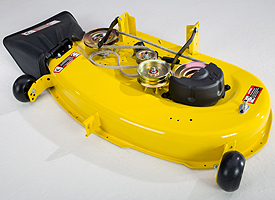 42-in. (107-cm) Edge cutting system
42-in. (107-cm) Edge cutting system
 42-in. (107-cm) Edge cutting system blades
42-in. (107-cm) Edge cutting system blades
The Edge cutting system has been trademarked to emphasize the advantages of the John Deere mower deck designs. They give superior convenience, performance, and reliability:
- The deep-deck mower design lifts grass for a clean, even cut.
- The smooth underside of mower prevents grass buildup and evenly disperses grass clippings.
- The rolled outer edge of the deck provides extra strength and protection.
- Dual-stage E-coat and powder paint coatings provide extra protection from rust.
S240 Tractor's mower deck features a number of durability upgrades compared to comparable John Deere 100 Series and competitive mower decks:
- Premium spindles (same as used on comparable Select Series™ decks)
- Larger anti-scalp wheels
- Upgraded fixed idler sheave bearing (increases life in dirty conditions)
- Upgraded spindle sheaves (same as used on 100 Series 54-in [137-cm] decks)
- Upgraded power take-off (PTO) drive sheave (improves belt life at lower heights of cut)
The 42-in. (107-cm) mower deck is a two-spindle design with heavy-duty characteristics:
- Two adjustable mower wheels are standard equipment for a smooth mowing job, even in rolling terrain.
- The flexible discharge chute minimizes property and mower deck damage.
- No tools are required to go from mulching (with mulch cover) to side discharge to rear bagging.
- A mulch cover is an optional attachment.
- A high-performance mulching blade is available to enhance mulching performance.
The mower deck has a rolled lip to provide greater strength and protection. The rugged 13 gauge, 0.09-in. (2.3-mm) steel-deck mower will provide years of dependable mowing.
The strength of the deck is enhanced by the top-discharge design:
- A section of material below the discharge opening ties the front and rear of the deck together.
- When using the rear bagger, material flows upward through the deck to provide highly effective bagging and a reduced chance of plugging.
- For this reason, no Power Flow™ collection system is available for the 42-in. (107-cm) mower.
Mower wash port
 Mower wash port
Mower wash port
 Mower wash port with hose connector
Mower wash port with hose connector
A wash port is provided to make cleaning the underside of the mower deck easy:
-
A hose connector is included with mower deck.
StarLock™ blade design
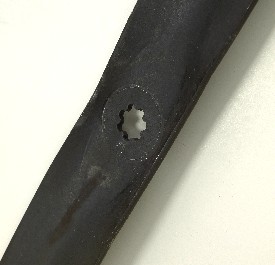 StarLock blade design
StarLock blade design
The StarLock blade design keeps the blade bolt at the correct torque for easy removal.
Optional blades for difficult mulching or bagging conditions are available.
Mower deck height adjustment
 Mower deck height adjustment lever
Mower deck height adjustment lever
The spring-assisted, low-effort lift lever simplifies setting and adjusting the mower cut height:
-
Increments of 1/4 in. (6.4 mm) allow the operator to fine-tune the cut height.
Optional mulching attachment or mulch cover
 Mulching attachment
Mulching attachment

The mulching attachment for the 42-in. (107-cm) mower provides excellent performance:
- Controls clippings from both blades effectively
- Improves mulching
- More even distribution of mulched clippings
- No rusting due to use of plastic molded parts
- Can be installed and removed without tools
- Includes special mulching blades
- Can also be used for side discharging, though the overall cut quality may decline slightly
 42-in. (107-cm) mulch cover
42-in. (107-cm) mulch cover
The mulch cover is available as an option for mulching grass or leaves. It is more convenient, but it provides a lower performance level than the mulching attachment.
Optional rear grass bagger
 6.5-bu (229-L) rear bagger
6.5-bu (229-L) rear bagger
 6.5-bu (229-L) rear bagger
6.5-bu (229-L) rear bagger
The hopper design provides efficient bagging performance, clean operation, and easy-to-empty bags:
- Two durable bags with a generous, 6.5-bu (229-L) capacity lift out for emptying and are easy to reinstall.
- An efficient lower chute provides smooth flow of material to reduce chance of plugging.
- Standard mower blades can be used for bagging, and high-lift blades are available for very difficult bagging conditions.
Three-year or 200-hour bumper-to-bumper warranty is standard
An exclusive 3-year or 200-hour (whichever comes first), single-source, bumper-to-bumper warranty* is standard for all John Deere S200 Series Tractors.
- The warranty is hassle free, with one company handling all of the paperwork.
- Premium features of S200 Series Tractors allow for this longer warranty period, with more coverage than comparable tractors.
*Term limited to years or hours used, whichever comes first, and varies by model. See the LIMITED WARRANTY FOR NEW JOHN DEERE TURF AND UTILITY EQUIPMENT at JohnDeere.com or JohnDeere.ca/TUWarranty for details.
Hydro/automatic drive gives an infinite choice of ground speeds
 Two-pedal foot control and cruise lever
Two-pedal foot control and cruise lever
 Hydro/automatic foot control in use
Hydro/automatic foot control in use
A Kanzaki® Tuff Torq® hydro/automatic transmission gives an infinite choice of speeds and makes changing the direction of travel easy.
Side-by-side foot pedals control the speed and direction of travel:
- The automotive-type accelerator controls ensure easy operation.
- The operator can change direction without lifting foot off the platform.
- A large pedal surface gives superior operator comfort.
 Hydro/automatic-transmission
Hydro/automatic-transmission
Appropriate transmissions are used in each model, depending on rear tire size and tractor performance requirements to ensure excellent performance and reliability:
-
The S240 Tractor has a Tuff Torq K46DP transaxle with an internal wet-disk brake for reliability and long life:
-
Rated for 30 percent more torque than the transaxle used in many lawn tractors
-
Uses Hy-Gard™ fluid like Select Series™ X300 Tractors
-
Standard cruise control
 Cruise control lever
Cruise control lever
Easy-to-use cruise control option maintains the tractor's speed for mowing larger areas.
-
To engage, lift up on the cruise lever and hold it until foot is removed from the forward pedal.
-
To disengage, lightly press and then release the forward pedal.
-
For emergency stops, cruise can be released by pushing on the brake pedal or pushing down on the cruise control lever.
Kanzaki and Tuff Torq are trademarks of Kanzaki Kokyukoki Manufacturing Company.
Snow removal is a strength of lawn tractors
 Snow blower, weather enclosure, weights, and chains on a 100 Series Tractor
Snow blower, weather enclosure, weights, and chains on a 100 Series Tractor
 Front blade, weather enclosure, and chains on a 100 Series Tractor
Front blade, weather enclosure, and chains on a 100 Series Tractor
An advantage of lawn tractors is their ability to use equipment for snow removal. Lawn tractor owners can add a John Deere snow blower or front blade to make quick work of moving snow whenever the need arises. Weather enclosure and tire-chain attachments add comfort and performance.
Equipment available for snow removal includes:
- 44-in. (112-cm) Snow Blower
- 46-in. (117-cm) Front Blade
- Tire chains or TerraGrip traction belts
- Weather enclosure
- Weights
Full-length, welded-steel frame and cast-iron front axle for reliability
 S240 Tractor
S240 Tractor
 Solid, one-piece frame and cast-iron front axle
Solid, one-piece frame and cast-iron front axle
Enhanced styling for the S240 Tractor includes a unique hood top:
- Close-out panels at the lower back of the hood are included for better looks and reduced engine sound level.
- Top louvers improve engine cooling.
The solid one-piece frame is constructed of 12-gauge, 0.105-in. (2.7-mm) steel:
- Full-length robotically welded frame design has high-strength steel rails for added strength and long life.
- One-piece fender deck is bolted to the frame.
- Two-bar front bumper is included as standard equipment to add style and protection.
 S240 Tractor
S240 Tractor
 Turf Trac tire tread
Turf Trac tire tread
The S240 comes with premium Turf Trac tires for superior traction and appearance:
- A more rounded profile reduces lawn scuffing and steering effort.
Cast-iron front axle will not bend
 Front axle and wheel spindle
Front axle and wheel spindle
The front axle is constructed of solid cast iron that will not bend:
- Automotive-like steering system with sector-and-pinion steering gears and single drag link and tie rod provides a very strong, low-effort, and tight-turning system.
- Grease fittings allow regular lubrication to help maintain easy steering and minimize wear.
- Large, 0.75-in. (19-mm) diameter wheel spindles provide excellent durability.
- Front wheels turn on ball bearings for increased reliability and life over other lawn tractors that have bushing for the front wheels.
CargO Mount™ system makes installation of rear bagger and other attachments easy
 Rear CargO Mount points
Rear CargO Mount points
 Front CargO Mount points
Front CargO Mount points
 Rear bagger is mounted with the rear CargO Mount points
Rear bagger is mounted with the rear CargO Mount points
The CargO Mount system is a combination of front and rear mounting points that provide convenient and easy installation of the rear bagger and other attachments.
Operator station designed for comfortable operation
Large, comfortable footrests
 S240 with Accel Deep Mower
S240 with Accel Deep Mower
 Comfortable operator station, left side
Comfortable operator station, left side
Wide footrest areas with non-slip, anti-vibration rubber footpads are provided for operator comfort and safety:
- Channels in the footrest design steer debris off to the side to keep the foot platform cleaner.
- Wider footrest makes it easier to step over the mower deck while entering or exiting the seat.
Comfortable seat
 Open-back seat
Open-back seat
 Easy-to-adjust seat
Easy-to-adjust seat
The operator seat can be easily adjusted forward or rearward while in the seat, with seat travel of 5.5 in. (140 mm) and 10 different positions:
- The open-back seat design keeps the operators back cooler.
- The green plastic seat adjustment lever is easy to locate and use.
- Slide pads on the bottom of the seat allow the seat to slide more easily for convenient adjustment.
 Rubber isolators under the seat give a smoother ride
Rubber isolators under the seat give a smoother ride
The seat can be tilted forward for protection from the elements and to provide easy access to the fuel tank:
- Rubber isolators under the seat smooth out the ride for greater operator comfort.
Convenient storage and service-interval decal
 Storage compartment with cover
Storage compartment with cover
 Convenient service-interval decal
Convenient service-interval decal
The beverage holder and storage compartment, located on the right fender, add value and operator convenience.
A decal located inside the hood gives quick access to basic service information.
Instruments and controls are easy to find and convenient to use
Controls and instruments
 Conveniently located controls
Conveniently located controls
Three-spoke steering wheel for greater operator comfort and control:
- Large, 14-in. (35.6-cm) diameter steering wheel gives greater comfort and control compared to smaller diameter steering wheels used on many lawn tractors.
The contoured dash has clean, attractive styling:
- Controls are color coded and labeled for easy identification by the operator.
- Controls are logically placed and easy to reach.
- The hour meter makes it easy to tell when oil changes and other maintenance should be performed.
- The ignition switch is on the dash for starting ease.
- Functional design of the controls provides good appearance and a comfortable feel.
 Engine speed lever and spring-loaded choke lever
Engine speed lever and spring-loaded choke lever
 Power take-off (PTO) switch
Power take-off (PTO) switch
The engine speed lever and choke control lever are separate controls:
- The engine speed lever is easy to use - there is no need to worry about pushing too far and engaging the choke as on single throttle/choke lever systems.
- The choke lever is spring loaded so the operator cannot accidentally operate the tractor with the choke on.
Mower drive is actuated with an easy-to-use electric PTO switch:
- The electric switch requires only a short movement compared to long throw required with manual PTO engagement lever.
- With an electric PTO clutch, the mower drive belt stays under tension at all times for improved reliability compared to manual PTO engagement systems.
Reverse implement option (RIO)
 RIO switch
RIO switch
Using RIO
CAUTION: Children or bystanders may be injured by rotating blades. Before traveling forward or rearward:
- Carefully check the area around the machine.
- Disengage the mower before backing up.
NOTE: Backing up while the mower is engaged is strongly discouraged. RIO should be used only when operating another attachment or when the operator deems it necessary to reposition the machine with the mower engaged.
- Stop forward travel.
- Look behind the machine to be sure there are no bystanders.
- Push and hold in the RIO switch while depressing the reverse pedal slightly.
NOTE: If the mower or other attachment stops while repositioning the machine, return the attachment engagement switch to the off position. Start engine and engage mower. Begin again with step 2.
- Release the RIO switch and reposition the machine as the machine begins to move rearward.
- Resume forward travel. The mower or other attachment should continue operating.
- Repeat procedure to position the machine again.
Cruise control
 Cruise control lever
Cruise control lever
 Cruise control lever and two-pedal foot control
Cruise control lever and two-pedal foot control
Cruise control is standard equipment:
- To engage, lift up on the cruise lever and hold until the foot is removed from the forward pedal.
- For emergency stop, the cruise control can be released by pushing on the brake pedal or the forward pedal.
Parking brake control
 Parking brake control
Parking brake control
 Brake pedal and parking brake control
Brake pedal and parking brake control
The parking brake control is conveniently located for easy access. It holds the brake pedal securely in the locked position.
Mower deck height adjustment and handgrip
 Mower deck height adjustment lever
Mower deck height adjustment lever
 Fender flare with handgrip
Fender flare with handgrip
The spring-assisted, low-effort lift lever simplifies setting and adjusting the mower cut height:
- Increments of 0.25 in. (0.64 cm) allow for fine-tuning the cut height.
Full-size fender flares include handgrips and reflectors for added safety.
Serviceability is convenient with easy-open hood
 One-piece hood is easy to open
One-piece hood is easy to open
 Service interval decal located under hood
Service interval decal located under hood
The one-piece hood opens easily to permit checking and servicing the engine:
- Important service points are located within easy reach.
- A service interval decal is provided inside the tractor hood for convenience when servicing the tractor.
- The high-quality engine used in the S240 does not require an 8-hour oil and filter change because improvements in the manufacturing process and quality of parts, components, and oils have eliminated the need for the short interval oil change requirement.
 Easy-to-service engine fuel and oil filters
Easy-to-service engine fuel and oil filters
 Easy access to fuel-fill opening
Easy access to fuel-fill opening
The engine fuel and oil filters, the oil check/fill tube, and the oil drain tube are exposed for serviceability when the hood is opened.
The seat tilts up and out of the way to make adding fuel easy.
The S240 Tractor is covered by a 3-year/200-hour bumper-to-bumper warranty*:
- Premium features of the S240 allow for this longer warranty period, with more coverage than other tractors of comparable size.
*Term limited to years or hours used, whichever comes first, and varies by model. See the LIMITED WARRANTY FOR NEW JOHN DEERE TURF AND UTILITY EQUIPMENT at JohnDeere.com or JohnDeere.ca/TUWarranty for details.
Hood will not dent or rust and includes quality headlights for good visibility
 One-piece hood opens for service access
One-piece hood opens for service access
 Quality headlights for good visibility
Quality headlights for good visibility
The hood is made of molded-in color material:
- Reduces sound
- Will not rust or dent
- Openings on the side of the hood let in plenty of cooling air while keeping the sound level low.
- Two headlights provide good lighting for nighttime operation.
The MowerPlus™ app helps maintain the tractor and lawn
 MowerPlus app screen
MowerPlus app screen
 MowerPlus app maintenance screen
MowerPlus app maintenance screen
Keep a John Deere riding lawn mower running its best and know how it mows with the John Deere MowerPlus app. Simply scan the lawn tractor’s barcode to get custom information. The app helps determine the best time to mow, communicates expert pre-mow tips, offers maintenance reminders, and provides walk-through guides.
Look for the MowerPlus app on the iOS® or Android™ system app stores.
The app supports residential lawn equipment such as 100 Series, S240, X300, X500, X700, Z200 through Z600, and many similarly-sized older products. It does not presently support tractor models numbered 1000 and larger, such as 1025R.
NOTE: Some product image variation may exist.
MowerPlus hour meter connector also available (sold separately)
 MowerPlus hour meter connector packaging
MowerPlus hour meter connector packaging
The John Deere MowerPlus hour meter connector wirelessly links a 100 Series or S240 Lawn Tractor to the MowerPlus app on a mobile device. The hour meter connector transmits engine usage to the app, making it easy to track maintenance intervals:
- iOS version 10 or higher is compatible with the hour meter connector.
- Android versions are not compatible with the hour meter connector at this time.
iOS is a trademark of Cisco Technology, Inc. used under license by Apple Inc. Android is a trademark of Google LLC.
Features
Engine is powerful and smooth-running V-twin design
 25-hp (18.6-kW) engine
25-hp (18.6-kW) engine
A 25-hp (18.6-kW) V-twin engine provides plenty of power and torque to handle tough mulching, mowing, and bagging conditions:
- V-twin cylinder design for greater torque, lower vibration, and improved sound quality
- Auto choke to allow operators to start the engine without needing the choke unless air temperatures are near or below freezing
- Electronic ignition for fast starts
- Spring-return feature to ensure the operator will not mistakenly leave the throttle lever in the choke position
- Cast-iron cylinder liners for longer engine life
- Overhead valves for excellent power and fuel economy
- Full-pressure lubrication and oil filter for cleaner oil, prolonging engine life and extending the time between oil changes
- Also more effective when operating the tractor on an incline
- Includes extended-life series (ELS) engine features for enhanced performance and longer life
- John Deere Easy Change™ 30-second oil change system makes changing the engine oil easy, quick, and clean.
Fuel tank has gauge to show fuel level from the operator's seat
 Fuel tank gauge
Fuel tank gauge
 Convenient fuel-filler opening
Convenient fuel-filler opening
The fuel tank gauge shows how much fuel is in the tank and can be seen without leaving the operator's seat:
- Easy to check fuel level
- Convenient location
Fuel tank:
- The capacity is 2.4 U.S. gal. (9.1 L).
- The fuel-filler opening is conveniently located under the seat.
- Filling the tank without spilling is easy.
- A tethered fuel tank cap is more convenient.
- The sealed fuel cap helps keep vapors inside the tank.
- The tractor has a California Air Resources Board (CARB) certified engine for reduced air pollution.
John Deere Easy Change™ 30-second oil change system
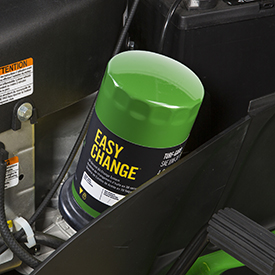 John Deere Easy Change 30-second oil change system
John Deere Easy Change 30-second oil change system
The John Deere Easy Change 30-second oil change system makes changing the engine oil easy, quick, and clean. Changing the oil is as easy as twisting on a new oil-filled filter. Oil does not need to be drained from the engine.
The John Deere Easy Change filter is an additional engine oil reservoir. Changing the filter removes the captured contaminants and replaces about 0.8 qt (0.76 L) of the engine oil.
The functionality does not stop with ease of use. The Easy Change oil system has several meaningful benefits over the traditional oil filter system of the 100 Series:
- A synthetic filter material is used for more predictable filtering and longer life.
- Filtering capacity is greater than with a standard oil filter.
- More filter surface area
- More oil flow capacity
- The system has 40 percent more oil volume.
- The oil and engine run cooler.
- The oil filter valve closes whenever the engine stops, so filtered particles are captured and cannot drain back into the engine.
- The risk of spilling during oil service is greatly reduced.
- Waste oil (and new oil production) is reduced by over 1,000,000 lb (453,592.4 kg) per tractor production year.
- This system is not a compromise to just make oil changes easier—these engines pass the same expectations and rigorous testing as always.
Partly due to these improvements, it is not necessary to remove and dispose of all the oil in the engine during service.
Everyone who uses the John Deere Easy Change system saves time and avoids the mess of a traditional oil change. In the past, many 100 Series Lawn Tractor owners rarely or never got around to changing their engine oil. With John Deere Easy Change, even owners who previously would not consider changing the oil themselves can easily do it. The Easy Change 30-second oil change system is a no-mess, no-fuss solution the competition cannot match.
Installation instructions are in the Operator’s Manual and in the John Deere Easy Change service part box.
Please recycle. Many local government recycling programs, authorized retailers, auto-service centers, and auto-parts stores will puncture and recycle used oil filters and oil.
Full-featured engine is more reliable and lasts longer
 24-hp (17.9-kW) engine shown
24-hp (17.9-kW) engine shown
This full-featured engine is engineered to deliver world-class endurance and power. A step above the competition, it is designed to be more dependable and longer lasting, saving time and money over the long run.
Built to exceed demanding needs by incorporating premium features and innovative designs:
- Overhead valve (OHV) design for cooler operation and longer valve life
- Contains an advanced debris management system that directs cooling air through the rotating screen to the air cleaner compartment, where large debris is pre-filtered through ejector slots
- Keeps unfiltered air out of the engine through a large, dual-sealed, premium oval-shaped cartridge-style filter
- Ensures maximum protection for extended engine life with the premium air cleaner, a pleated paper filter with a foam precleaner
- Captures fine particles for maximum protection and extended maintenance
- Provides maximum protection with full-pressure lubrication system
- Pumps oil by a mechanical gerotor-style pump to all critical engine components
- Enhances the system through a premium automotive-style oil filter, which removes over 95 percent of oil contaminates
- A premium bearing package for improved durability; includes a super-finished crank pin bearing with a 50 percent smoother surface to increase load capacity by 35 percent
- Uses a premium DU Teflon®-coated bearing
- Helps resist wear and increases durability through self-lubricating bronze bearing
- Wear-resistant, chrome-plated valve stems for long-life valves
- 44 percent smoother for longer life
- Cast-iron cylinder sleeve for extended life
- Dependable float-feed type carburetor with integral fuel pump
- High-capacity fuel filter for dependable operation
- Includes John Deere Easy Change™ 30-second oil change system for making it easy, quick, and clean to change the oil
- Maintenance-free electronic ignition for quick, dependable starts
- Platinum spark plugs for extended life
Teflon is a trademark of The Chemours Company.
Frame made of full-length welded steel for reliability
 Solid one-piece frame
Solid one-piece frame
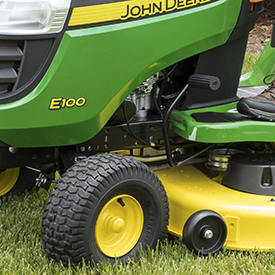 Solid one-piece frame
Solid one-piece frame
The solid one-piece frame is constructed of 12-gauge, 0.105-in. (2.66-mm) steel:
- Full-length, robotically-welded frame design has high-strength steel rails for added strength and long life.
- One-piece, steel fender deck is bolted to the frame.
Cast-iron front axle will not bend
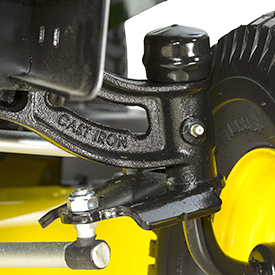 Front axle and wheel spindle
Front axle and wheel spindle
The front axle is constructed of solid cast iron that will not bend:
- Automotive-like steering system with sector and pinion steering gears and single drag link with a tie rod provides a very strong, low-effort, and tight-turning system.
- Three grease fittings, on both steering spindles and center pivot, allow for regular lubrication to help maintain easy steering and minimize wear.
- Large, 0.75-in. (1.9-cm) diameter wheel spindles provide excellent durability.
CargO Mount™ system makes installation of rear bagger and other attachments easy
 Rear CargO Mount points
Rear CargO Mount points
 Front CargO Mount points
Front CargO Mount points
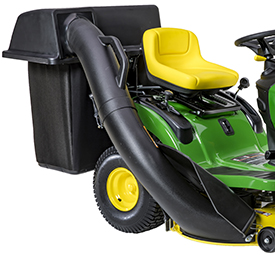 Rear bagger is mounted with CargO Mount points
Rear bagger is mounted with CargO Mount points
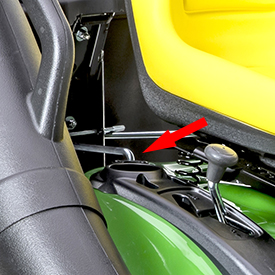 Rear bagger is mounted with CargO Mount points
Rear bagger is mounted with CargO Mount points
The CargO Mount system is a combination of front- and rear-mounting points providing convenient and easy installation of the sun canopy, rear bagger, and other attachments.
Snow removal is a strength of lawn tractors
 Snow blower, weather enclosure, weights, and chains on a 100 Series Tractor
Snow blower, weather enclosure, weights, and chains on a 100 Series Tractor
 Front blade, weather enclosure, and chains on a 100 Series Tractor
Front blade, weather enclosure, and chains on a 100 Series Tractor
An advantage of lawn tractors is their ability to use equipment for snow removal. Lawn tractor owners can add a John Deere snow blower or front blade to make quick work of moving snow whenever the need arises. Weather enclosure and tire-chain attachments add comfort and performance.
Equipment available for snow removal includes:
- 44-in. (112-cm) Snow Blower
- 46-in. (117-cm) Front Blade
- Tire chains or TerraGrip traction belts
- Weather enclosure
- Weights
Hydrostatic transmission gives an infinite choice of ground speeds
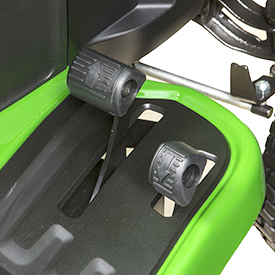 Two-pedal speed/direction controls
Two-pedal speed/direction controls
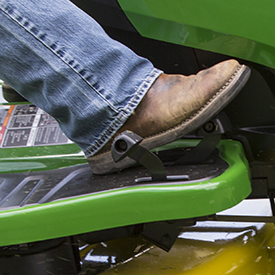 Forward speed control pedal in use
Forward speed control pedal in use
A Kanzaki® Tuff Torq® hydrostatic transmission gives an infinite choice of speeds and makes changing the direction of travel easy. Side-by-side foot pedals control the speed and direction of travel:
- Automotive-type accelerator controls ensure easy operation.
- Operator can change direction without lifting foot off the platform.
- Large pedal surface gives superior operator comfort.
 Hydrostatic transmission
Hydrostatic transmission
Appropriate transmissions are used in each model, depending on rear tire size and tractor performance requirements, to ensure excellent performance and reliability:
- Tuff Torq TLT200A - E110, E120, E130
- Tuff Torq TLT200B - E140, E150, E160
- Tuff Torq K46AC - E170, E180
Standard cruise control (E120, E130, E150, E160, E170, and E180)
 Cruise control lever
Cruise control lever
An easy-to-use cruise control option maintains the tractor's speed for mowing larger areas:
- To engage, lift up on the cruise lever and hold it until the foot is removed from the forward pedal.
- To disengage, lightly press and then release the forward pedal.
- For emergency stops, cruise can be released by pushing on the brake pedal or pushing down on the cruise control lever.
NOTE: Cruise control is available on all models except the E100, E110, and E140.
Kanzaki and Tuff Torq are trademarks of Kanzaki Kokyukoki Manufacturing Company.
Operator station designed for comfortable operation
 Operator station is designed for comfort (E160 shown)
Operator station is designed for comfort (E160 shown)
 Comfortable operator station, left side (E170 shown)
Comfortable operator station, left side (E170 shown)
The operator station is designed for operator comfort and easy operation:
- Controls are positioned where they are easy to reach and use to control the tractor.
- The steering wheel is positioned and angled to give the operator plenty of room and steering comfort.
- The seat is tilted back at the optimum angle to provide the most comfortable operator position.
 Steering wheel and dash
Steering wheel and dash
 Wide footrest with debris channels
Wide footrest with debris channels
Controls are easy to see and use:
- A deluxe, 14-in. (35.6-cm) steering wheel provides greater operator comfort and control.
- Ignition switch is on the dash for starting ease.
Wide footrest areas with non-slip, anti-vibration rubber floor mats are provided for operator comfort:
- Debris removing channels help keep the footrest area clean and dry.
- The wide footrest makes it easier to step over the mower deck while entering or exiting the seat.
 Comfort Plus lumbar seat
Comfort Plus lumbar seat
 Comfort Plus lumbar seat
Comfort Plus lumbar seat
 Lumbar seat adjustment knob
Lumbar seat adjustment knob
 Easy-to-adjust seat
Easy-to-adjust seat
A 15-in. (38.1-cm), high-back, deluxe operator seat provides good support and lumbar adjustment for extra operator comfort. It is especially helpful when operating the tractor for extended periods of time.
The seat can be easily adjusted forward or rearward while in it, with seat travel of 5.5 in. (14 cm) and 10 different positions.
 Seat springs give a smoother ride
Seat springs give a smoother ride
 Seat tilted forward (shown on E180 Tractor)
Seat tilted forward (shown on E180 Tractor)
Two long seat springs give plenty of seat travel to smooth out the ride, keeping the operator comfortable while operating the tractor.
The seat can be tilted forward for protection from the elements and to provide easy access to the fuel tank.
 Beverage holder
Beverage holder
 Storage compartment
Storage compartment
A beverage holder and storage compartment, located on the right fender, are conveniently located and easy to use.
 Handgrip on fender
Handgrip on fender
Handgrips give extra comfort for the operator, especially when operating on hillsides. Reflectors make the tractor more visible.
Instruments and controls are easy to find and convenient to use
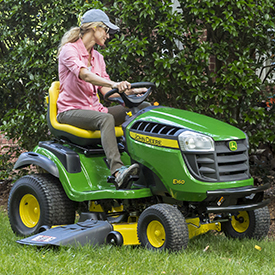 E160 Tractor mowing
E160 Tractor mowing
 Steering wheel and controls
Steering wheel and controls
Instruments and controls
The contoured dash has clean, attractive styling:
-
Controls are color coded and labeled for easy identification by the operator.
-
Controls are logically placed and easy to reach.
-
The hour meter makes it easy to tell when oil changes and other maintenance should be performed.
- A service reminder feature will indicate that a general lubrication or mower/engine service interval has been reached.
- When service is required, arrows will periodically flash for two hours.
-
Functional design of the controls provides good appearance and a comfortable feel.
Side-by-side transmission control pedals
 Two-pedal speed/direction controls
Two-pedal speed/direction controls
 Side-by-side foot pedals and cruise control lever
Side-by-side foot pedals and cruise control lever
Side-by-side foot pedals control the speed and direction of travel:
- Automotive-type accelerator controls ensure easy operation.
- Operator can change direction without lifting foot off the platform.
- Large pedal surface gives superior operator comfort.
Cruise control (E120, E130, E150, E160, E170, and E180)
 Cruise control lever
Cruise control lever
Cruise control is available on the E120, E130, E150, E160, E170, and the E180:
- To engage, lift up on the cruise lever and hold until the foot is removed from the forward pedal.
- For emergency stop, the cruise control can be released by pushing on the brake pedal or the forward pedal.
Mower deck height adjustment
 Mower deck height adjustment lever
Mower deck height adjustment lever
 Mower deck height adjustment lever
Mower deck height adjustment lever
A spring-assisted, low-effort lift lever simplifies setting and adjusting the mower cut height:
-
Increments of 0.25 in. (0.64 cm) allow fine-tuning the cut height.
-
Cut height is adjustable from 1 in. (2.5 cm) to 4 in. (10.2 cm).
Parking brake control
 Brake/parking brake pedal
Brake/parking brake pedal
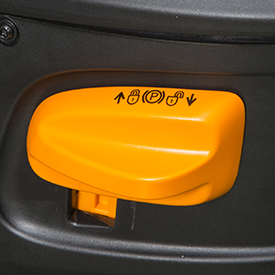 Parking brake lever
Parking brake lever
The parking brake control is conveniently located for easy access. It holds the brake pedal securely in the locked position.
Electric power take-off (PTO) clutch is easy and convenient to use
 Electric PTO engagement switch
Electric PTO engagement switch
The heavy-duty electric PTO clutch is operated with a convenient dash-mounted switch.
Reverse implement option (RIO)
 RIO switch
RIO switch
Using RIO
CAUTION: Children or bystanders may be injured by rotating blades. Before traveling forward or rearward:
- Carefully check the area around the machine.
- Disengage the mower before backing up.
NOTE: Backing up while the mower is engaged is strongly discouraged. RIO should be used only when operating another attachment or when the operator deems it necessary to reposition the machine with the mower engaged.
- Stop forward travel.
- Look behind the machine to be sure there are no bystanders.
- Push and hold in the RIO switch while depressing the reverse pedal slightly for a hydrostatic transmission or moving the transmission shift lever to the rear slot (reverse) for a continuously variable transmission (CVT)/automatic transmission.
NOTE: If the engine and mower or other attachment stops while repositioning the machine, return the attachment engagement lever/switch to the off position. Start the engine and engage mower or other attachment. Begin again with step 2.
- Release the RIO switch and reposition the machine as the machine begins to move rearward.
- Resume forward travel. The mower or other attachment should continue operating.
- Repeat procedure to position the machine again.
Serviceability is convenient with easy-open hood
 One-piece hood is easy to open
One-piece hood is easy to open
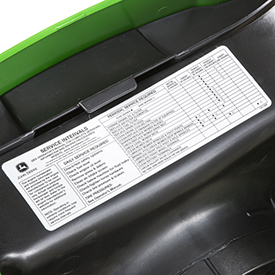 Service interval decal located under hood
Service interval decal located under hood
The one-piece hood opens easily to permit checking and servicing the engine:
- Important service points are located within easy reach.
- A service-interval decal is provided inside the tractor hood for convenience when servicing the tractor.
 John Deere Easy Change™ 30-second oil change system
John Deere Easy Change™ 30-second oil change system
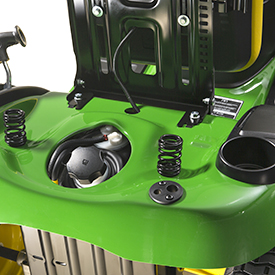 Seat tilted up for easy access to fuel-fill opening
Seat tilted up for easy access to fuel-fill opening
The John Deere Easy Change 30-second oil change system makes changing the engine oil easy, quick, and clean. Changing the oil is as easy as removing the old oil-filled filter and twisting on a new oil-filled filter. Oil does not need to be drained from the engine. The removed filter contains the captured contaminants and a portion of the engine oil.
The seat tilts up and out of the way to make adding fuel easy.
The 100 Series Tractors are covered by a 2-year/120-hour bumper-to-bumper warranty*:
- Premium features of 100 Series Tractors allow for this long warranty period.
*Term limited to years or hours used, whichever comes first, and varies by model. See the LIMITED WARRANTY FOR NEW JOHN DEERE TURF AND UTILITY EQUIPMENT at JohnDeere.com or JohnDeere.ca/TUWarranty for details.
Hood will not dent or rust and includes quality headlights for good visibility
 One-piece hood opens for service access
One-piece hood opens for service access
 Quality headlights for good visibility
Quality headlights for good visibility
The hood is made of molded-in color material:
- Reduces sound
- Will not rust or dent
- Openings on the side of the hood let in plenty of cooling air while keeping the sound level low.
- Two headlights provide good lighting for nighttime operation.
The MowerPlus™ app helps maintain the tractor and lawn
 MowerPlus app screen
MowerPlus app screen
 MowerPlus app maintenance screen
MowerPlus app maintenance screen
Keep a John Deere riding lawn mower running its best and know how it mows with the John Deere MowerPlus app. Simply scan the lawn tractor’s barcode to get custom information. The app helps determine the best time to mow, communicates expert pre-mow tips, offers maintenance reminders, and provides walk-through guides.
Look for the MowerPlus app on the iOS® or Android™ system app stores.
The app supports residential lawn equipment such as 100 Series, S240, X300, X500, X700, Z200 through Z600, and many similarly-sized older products. It does not presently support tractor models numbered 1000 and larger, such as 1025R.
NOTE: Some product image variation may exist.
MowerPlus hour meter connector also available (sold separately)
 MowerPlus hour meter connector packaging
MowerPlus hour meter connector packaging
The John Deere MowerPlus hour meter connector wirelessly links a 100 Series or S240 Lawn Tractor to the MowerPlus app on a mobile device. The hour meter connector transmits engine usage to the app, making it easy to track maintenance intervals:
- iOS version 10 or higher is compatible with the hour meter connector.
- Android versions are not compatible with the hour meter connector at this time.
iOS is a trademark of Cisco Technology, Inc. used under license by Apple Inc. Android is a trademark of Google LLC.
The Edge™ cutting system gives superior performance
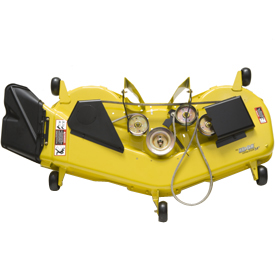 The Edge cutting system
The Edge cutting system

The Edge cutting system has been trademarked to emphasize the advantages of the John Deere mower deck designs. They give superior mowing convenience, performance, and reliability:
- Deep-deck mower design lifts grass for a clean, even cut.
- Smooth underside of the mower prevents grass buildup and evenly disperses grass clippings.
- The rolled outer edge of the deck provides extra strength and protection.
- Dual-stage E-coat and powder paint coatings provide extra protection from rust.
The 54-in. (137-cm) Edge Mower Deck is a three-spindle, heavy-duty, 11-gauge, 0.120-in. (3-mm) steel deck with rolled edges for added strength:
- Deck includes five anti-scalp wheels for a smooth mowing job, even in rolling terrain.
- Flexible discharge chute minimizes property and mower damage.
- A 6.5 bu (229-L) Power Flow™ material collection system is available.
- The mower comes with standard blades that work good when side discharging and when collecting material with the 6.5-bu (229-L) Power Flow material collection system.
- A mulching attachment is sold separately; special blades for mulching are included with the mulching attachment.
Mower wash port
 Mower wash port
Mower wash port
 Mower wash port with hose connector
Mower wash port with hose connector
A wash port is provided to make cleaning the underside of the mower deck easy:
-
A hose connector included with mower deck.
Mower deck height adjustment
 Mower deck height adjustment lever
Mower deck height adjustment lever
 Mower deck height adjustment lever
Mower deck height adjustment lever
A spring-assisted, low-effort lift lever simplifies setting and adjusting the mower cut height:
- Increments of 0.25 in. (0.64 cm) allow the operator to fine-tune the cut height.
- Cut height is adjustable from 1 in. (2.5 cm) to 4 in. (10.2 cm).
- The lift handle is shaped and located for easy use and is out of the way of entering or exiting operators.
Two-year or 120-hour bumper-to-bumper warranty is standard
An exclusive 2-year or 120-hour (whichever comes first), single-source, bumper-to-bumper warranty* is standard for all John Deere 100 Series Tractors.
- The warranty is hassle free, with one company handling all of the paperwork.
- Premium features of 100 Series Tractors allow for this longer warranty period, with more coverage than comparable tractors.
*Term limited to years or hours used, whichever comes first, and varies by model. See the LIMITED WARRANTY FOR NEW JOHN DEERE TURF AND UTILITY EQUIPMENT at JohnDeere.com or JohnDeere.ca/TUWarranty for details.
Features
Engine is powerful and smooth-running V-twin design
 25-hp (18.6-kW) engine
25-hp (18.6-kW) engine
A 25-hp (18.6-kW) V-twin engine provides plenty of power and torque to handle tough mulching, mowing, and bagging conditions:
- V-twin cylinder design for greater torque, lower vibration, and improved sound quality
- Auto choke to allow operators to start the engine without needing the choke unless air temperatures are near or below freezing
- Electronic ignition for fast starts
- Spring-return feature to ensure the operator will not mistakenly leave the throttle lever in the choke position
- Cast-iron cylinder liners for longer engine life
- Overhead valves for excellent power and fuel economy
- Full-pressure lubrication and oil filter for cleaner oil, prolonging engine life and extending the time between oil changes
- Also more effective when operating the tractor on an incline
- Includes extended-life series (ELS) engine features for enhanced performance and longer life
- John Deere Easy Change™ 30-second oil change system makes changing the engine oil easy, quick, and clean.
Fuel tank has gauge to show fuel level from the operator's seat
 Fuel tank gauge
Fuel tank gauge
 Convenient fuel-filler opening
Convenient fuel-filler opening
The fuel tank gauge shows how much fuel is in the tank and can be seen without leaving the operator's seat:
- Easy to check fuel level
- Convenient location
Fuel tank:
- The capacity is 2.4 U.S. gal. (9.1 L).
- The fuel-filler opening is conveniently located under the seat.
- Filling the tank without spilling is easy.
- A tethered fuel tank cap is more convenient.
- The sealed fuel cap helps keep vapors inside the tank.
- The tractor has a California Air Resources Board (CARB) certified engine for reduced air pollution.
John Deere Easy Change™ 30-second oil change system
 John Deere Easy Change 30-second oil change system
John Deere Easy Change 30-second oil change system
The John Deere Easy Change 30-second oil change system makes changing the engine oil easy, quick, and clean. Changing the oil is as easy as twisting on a new oil-filled filter. Oil does not need to be drained from the engine.
The John Deere Easy Change filter is an additional engine oil reservoir. Changing the filter removes the captured contaminants and replaces about 0.8 qt (0.76 L) of the engine oil.
The functionality does not stop with ease of use. The Easy Change oil system has several meaningful benefits over the traditional oil filter system of the 100 Series:
- A synthetic filter material is used for more predictable filtering and longer life.
- Filtering capacity is greater than with a standard oil filter.
- More filter surface area
- More oil flow capacity
- The system has 40 percent more oil volume.
- The oil and engine run cooler.
- The oil filter valve closes whenever the engine stops, so filtered particles are captured and cannot drain back into the engine.
- The risk of spilling during oil service is greatly reduced.
- Waste oil (and new oil production) is reduced by over 1,000,000 lb (453,592.4 kg) per tractor production year.
- This system is not a compromise to just make oil changes easier—these engines pass the same expectations and rigorous testing as always.
Partly due to these improvements, it is not necessary to remove and dispose of all the oil in the engine during service.
Everyone who uses the John Deere Easy Change system saves time and avoids the mess of a traditional oil change. In the past, many 100 Series Lawn Tractor owners rarely or never got around to changing their engine oil. With John Deere Easy Change, even owners who previously would not consider changing the oil themselves can easily do it. The Easy Change 30-second oil change system is a no-mess, no-fuss solution the competition cannot match.
Installation instructions are in the Operator’s Manual and in the John Deere Easy Change service part box.
Please recycle. Many local government recycling programs, authorized retailers, auto-service centers, and auto-parts stores will puncture and recycle used oil filters and oil.
Full-featured engine is more reliable and lasts longer
 24-hp (17.9-kW) engine shown
24-hp (17.9-kW) engine shown
This full-featured engine is engineered to deliver world-class endurance and power. A step above the competition, it is designed to be more dependable and longer lasting, saving time and money over the long run.
Built to exceed demanding needs by incorporating premium features and innovative designs:
- Overhead valve (OHV) design for cooler operation and longer valve life
- Contains an advanced debris management system that directs cooling air through the rotating screen to the air cleaner compartment, where large debris is pre-filtered through ejector slots
- Keeps unfiltered air out of the engine through a large, dual-sealed, premium oval-shaped cartridge-style filter
- Ensures maximum protection for extended engine life with the premium air cleaner, a pleated paper filter with a foam precleaner
- Captures fine particles for maximum protection and extended maintenance
- Provides maximum protection with full-pressure lubrication system
- Pumps oil by a mechanical gerotor-style pump to all critical engine components
- Enhances the system through a premium automotive-style oil filter, which removes over 95 percent of oil contaminates
- A premium bearing package for improved durability; includes a super-finished crank pin bearing with a 50 percent smoother surface to increase load capacity by 35 percent
- Uses a premium DU Teflon®-coated bearing
- Helps resist wear and increases durability through self-lubricating bronze bearing
- Wear-resistant, chrome-plated valve stems for long-life valves
- 44 percent smoother for longer life
- Cast-iron cylinder sleeve for extended life
- Dependable float-feed type carburetor with integral fuel pump
- High-capacity fuel filter for dependable operation
- Includes John Deere Easy Change™ 30-second oil change system for making it easy, quick, and clean to change the oil
- Maintenance-free electronic ignition for quick, dependable starts
- Platinum spark plugs for extended life
Teflon is a trademark of The Chemours Company.
Frame made of full-length welded steel for reliability
 Solid one-piece frame
Solid one-piece frame
 Solid one-piece frame
Solid one-piece frame
The solid one-piece frame is constructed of 12-gauge, 0.105-in. (2.66-mm) steel:
- Full-length, robotically-welded frame design has high-strength steel rails for added strength and long life.
- One-piece, steel fender deck is bolted to the frame.
Cast-iron front axle will not bend
 Front axle and wheel spindle
Front axle and wheel spindle
The front axle is constructed of solid cast iron that will not bend:
- Automotive-like steering system with sector and pinion steering gears and single drag link with a tie rod provides a very strong, low-effort, and tight-turning system.
- Three grease fittings, on both steering spindles and center pivot, allow for regular lubrication to help maintain easy steering and minimize wear.
- Large, 0.75-in. (1.9-cm) diameter wheel spindles provide excellent durability.
CargO Mount™ system makes installation of rear bagger and other attachments easy
 Rear CargO Mount points
Rear CargO Mount points
 Front CargO Mount points
Front CargO Mount points
 Rear bagger is mounted with CargO Mount points
Rear bagger is mounted with CargO Mount points
 Rear bagger is mounted with CargO Mount points
Rear bagger is mounted with CargO Mount points
The CargO Mount system is a combination of front- and rear-mounting points providing convenient and easy installation of the sun canopy, rear bagger, and other attachments.
Snow removal is a strength of lawn tractors
 Snow blower, weather enclosure, weights, and chains on a 100 Series Tractor
Snow blower, weather enclosure, weights, and chains on a 100 Series Tractor
 Front blade, weather enclosure, and chains on a 100 Series Tractor
Front blade, weather enclosure, and chains on a 100 Series Tractor
An advantage of lawn tractors is their ability to use equipment for snow removal. Lawn tractor owners can add a John Deere snow blower or front blade to make quick work of moving snow whenever the need arises. Weather enclosure and tire-chain attachments add comfort and performance.
Equipment available for snow removal includes:
- 44-in. (112-cm) Snow Blower
- 46-in. (117-cm) Front Blade
- Tire chains or TerraGrip traction belts
- Weather enclosure
- Weights
Hydrostatic transmission gives an infinite choice of ground speeds
 Two-pedal speed/direction controls
Two-pedal speed/direction controls
 Forward speed control pedal in use
Forward speed control pedal in use
A Kanzaki® Tuff Torq® hydrostatic transmission gives an infinite choice of speeds and makes changing the direction of travel easy. Side-by-side foot pedals control the speed and direction of travel:
- Automotive-type accelerator controls ensure easy operation.
- Operator can change direction without lifting foot off the platform.
- Large pedal surface gives superior operator comfort.
 Hydrostatic transmission
Hydrostatic transmission
Appropriate transmissions are used in each model, depending on rear tire size and tractor performance requirements, to ensure excellent performance and reliability:
- Tuff Torq TLT200A - E110, E120, E130
- Tuff Torq TLT200B - E140, E150, E160
- Tuff Torq K46AC - E170, E180
Standard cruise control (E120, E130, E150, E160, E170, and E180)
 Cruise control lever
Cruise control lever
An easy-to-use cruise control option maintains the tractor's speed for mowing larger areas:
- To engage, lift up on the cruise lever and hold it until the foot is removed from the forward pedal.
- To disengage, lightly press and then release the forward pedal.
- For emergency stops, cruise can be released by pushing on the brake pedal or pushing down on the cruise control lever.
NOTE: Cruise control is available on all models except the E100, E110, and E140.
Kanzaki and Tuff Torq are trademarks of Kanzaki Kokyukoki Manufacturing Company.
Operator station designed for comfortable operation
 Operator station is designed for comfort (E160 shown)
Operator station is designed for comfort (E160 shown)
 Comfortable operator station, left side (E170 shown)
Comfortable operator station, left side (E170 shown)
The operator station is designed for operator comfort and easy operation:
- Controls are positioned where they are easy to reach and use to control the tractor.
- The steering wheel is positioned and angled to give the operator plenty of room and steering comfort.
- The seat is tilted back at the optimum angle to provide the most comfortable operator position.
 Steering wheel and dash
Steering wheel and dash
 Wide footrest with debris channels
Wide footrest with debris channels
Controls are easy to see and use:
- A deluxe, 14-in. (35.6-cm) steering wheel provides greater operator comfort and control.
- Ignition switch is on the dash for starting ease.
Wide footrest areas with non-slip, anti-vibration rubber floor mats are provided for operator comfort:
- Debris removing channels help keep the footrest area clean and dry.
- The wide footrest makes it easier to step over the mower deck while entering or exiting the seat.
 Comfort Plus lumbar seat
Comfort Plus lumbar seat
 Comfort Plus lumbar seat
Comfort Plus lumbar seat
 Lumbar seat adjustment knob
Lumbar seat adjustment knob
 Easy-to-adjust seat
Easy-to-adjust seat
A 15-in. (38.1-cm), high-back, deluxe operator seat provides good support and lumbar adjustment for extra operator comfort. It is especially helpful when operating the tractor for extended periods of time.
The seat can be easily adjusted forward or rearward while in it, with seat travel of 5.5 in. (14 cm) and 10 different positions.
 Seat springs give a smoother ride
Seat springs give a smoother ride
 Seat tilted forward (shown on E180 Tractor)
Seat tilted forward (shown on E180 Tractor)
Two long seat springs give plenty of seat travel to smooth out the ride, keeping the operator comfortable while operating the tractor.
The seat can be tilted forward for protection from the elements and to provide easy access to the fuel tank.
 Beverage holder
Beverage holder
 Storage compartment
Storage compartment
A beverage holder and storage compartment, located on the right fender, are conveniently located and easy to use.
 Handgrip on fender
Handgrip on fender
Handgrips give extra comfort for the operator, especially when operating on hillsides. Reflectors make the tractor more visible.
Instruments and controls are easy to find and convenient to use
 E160 Tractor mowing
E160 Tractor mowing
 Steering wheel and controls
Steering wheel and controls
Instruments and controls
The contoured dash has clean, attractive styling:
-
Controls are color coded and labeled for easy identification by the operator.
-
Controls are logically placed and easy to reach.
-
The hour meter makes it easy to tell when oil changes and other maintenance should be performed.
- A service reminder feature will indicate that a general lubrication or mower/engine service interval has been reached.
- When service is required, arrows will periodically flash for two hours.
-
Functional design of the controls provides good appearance and a comfortable feel.
Side-by-side transmission control pedals
 Two-pedal speed/direction controls
Two-pedal speed/direction controls
 Side-by-side foot pedals and cruise control lever
Side-by-side foot pedals and cruise control lever
Side-by-side foot pedals control the speed and direction of travel:
- Automotive-type accelerator controls ensure easy operation.
- Operator can change direction without lifting foot off the platform.
- Large pedal surface gives superior operator comfort.
Cruise control (E120, E130, E150, E160, E170, and E180)
 Cruise control lever
Cruise control lever
Cruise control is available on the E120, E130, E150, E160, E170, and the E180:
- To engage, lift up on the cruise lever and hold until the foot is removed from the forward pedal.
- For emergency stop, the cruise control can be released by pushing on the brake pedal or the forward pedal.
Mower deck height adjustment
 Mower deck height adjustment lever
Mower deck height adjustment lever
 Mower deck height adjustment lever
Mower deck height adjustment lever
A spring-assisted, low-effort lift lever simplifies setting and adjusting the mower cut height:
-
Increments of 0.25 in. (0.64 cm) allow fine-tuning the cut height.
-
Cut height is adjustable from 1 in. (2.5 cm) to 4 in. (10.2 cm).
Parking brake control
 Brake/parking brake pedal
Brake/parking brake pedal
 Parking brake lever
Parking brake lever
The parking brake control is conveniently located for easy access. It holds the brake pedal securely in the locked position.
Electric power take-off (PTO) clutch is easy and convenient to use
 Electric PTO engagement switch
Electric PTO engagement switch
The heavy-duty electric PTO clutch is operated with a convenient dash-mounted switch.
Reverse implement option (RIO)
 RIO switch
RIO switch
Using RIO
CAUTION: Children or bystanders may be injured by rotating blades. Before traveling forward or rearward:
- Carefully check the area around the machine.
- Disengage the mower before backing up.
NOTE: Backing up while the mower is engaged is strongly discouraged. RIO should be used only when operating another attachment or when the operator deems it necessary to reposition the machine with the mower engaged.
- Stop forward travel.
- Look behind the machine to be sure there are no bystanders.
- Push and hold in the RIO switch while depressing the reverse pedal slightly for a hydrostatic transmission or moving the transmission shift lever to the rear slot (reverse) for a continuously variable transmission (CVT)/automatic transmission.
NOTE: If the engine and mower or other attachment stops while repositioning the machine, return the attachment engagement lever/switch to the off position. Start the engine and engage mower or other attachment. Begin again with step 2.
- Release the RIO switch and reposition the machine as the machine begins to move rearward.
- Resume forward travel. The mower or other attachment should continue operating.
- Repeat procedure to position the machine again.
Serviceability is convenient with easy-open hood
 One-piece hood is easy to open
One-piece hood is easy to open
 Service interval decal located under hood
Service interval decal located under hood
The one-piece hood opens easily to permit checking and servicing the engine:
- Important service points are located within easy reach.
- A service-interval decal is provided inside the tractor hood for convenience when servicing the tractor.
 John Deere Easy Change™ 30-second oil change system
John Deere Easy Change™ 30-second oil change system
 Seat tilted up for easy access to fuel-fill opening
Seat tilted up for easy access to fuel-fill opening
The John Deere Easy Change 30-second oil change system makes changing the engine oil easy, quick, and clean. Changing the oil is as easy as removing the old oil-filled filter and twisting on a new oil-filled filter. Oil does not need to be drained from the engine. The removed filter contains the captured contaminants and a portion of the engine oil.
The seat tilts up and out of the way to make adding fuel easy.
The 100 Series Tractors are covered by a 2-year/120-hour bumper-to-bumper warranty*:
- Premium features of 100 Series Tractors allow for this long warranty period.
*Term limited to years or hours used, whichever comes first, and varies by model. See the LIMITED WARRANTY FOR NEW JOHN DEERE TURF AND UTILITY EQUIPMENT at JohnDeere.com or JohnDeere.ca/TUWarranty for details.
Hood will not dent or rust and includes quality headlights for good visibility
 One-piece hood opens for service access
One-piece hood opens for service access
 Quality headlights for good visibility
Quality headlights for good visibility
The hood is made of molded-in color material:
- Reduces sound
- Will not rust or dent
- Openings on the side of the hood let in plenty of cooling air while keeping the sound level low.
- Two headlights provide good lighting for nighttime operation.
The MowerPlus™ app helps maintain the tractor and lawn
 MowerPlus app screen
MowerPlus app screen
 MowerPlus app maintenance screen
MowerPlus app maintenance screen
Keep a John Deere riding lawn mower running its best and know how it mows with the John Deere MowerPlus app. Simply scan the lawn tractor’s barcode to get custom information. The app helps determine the best time to mow, communicates expert pre-mow tips, offers maintenance reminders, and provides walk-through guides.
Look for the MowerPlus app on the iOS® or Android™ system app stores.
The app supports residential lawn equipment such as 100 Series, S240, X300, X500, X700, Z200 through Z600, and many similarly-sized older products. It does not presently support tractor models numbered 1000 and larger, such as 1025R.
NOTE: Some product image variation may exist.
MowerPlus hour meter connector also available (sold separately)
 MowerPlus hour meter connector packaging
MowerPlus hour meter connector packaging
The John Deere MowerPlus hour meter connector wirelessly links a 100 Series or S240 Lawn Tractor to the MowerPlus app on a mobile device. The hour meter connector transmits engine usage to the app, making it easy to track maintenance intervals:
- iOS version 10 or higher is compatible with the hour meter connector.
- Android versions are not compatible with the hour meter connector at this time.
iOS is a trademark of Cisco Technology, Inc. used under license by Apple Inc. Android is a trademark of Google LLC.
The Edge™ cutting system gives superior performance
 E160 Tractor with 48-in. (122-cm) Edge cutting system
E160 Tractor with 48-in. (122-cm) Edge cutting system
 48-in. (122-cm) Edge cutting system
48-in. (122-cm) Edge cutting system

The Edge cutting system has been trademarked to emphasize the advantages of the John Deere mower deck designs. They give superior convenience, performance, and reliability:
- Deep-deck mower design lifts grass for a clean, even cut.
- Smooth underside of mower prevents grass buildup and evenly disperses grass clippings.
- The rolled outer edge of the deck provides extra strength and protection.
- Dual-stage E-coat and powder paint coatings provide extra protection from rust.
The 48-in. (121.9-cm) Edge mower deck is a three-spindle design with heavy-duty characteristics:
- Four mower wheels are standard equipment for a smooth mowing job, even in rolling terrain.
- Flexible discharge chute minimizes property and mower deck damage.
- No tools are required to go from mulching (with mulch cover) to side discharge to rear bagging.
- A mulch cover is an optional attachment that can be installed without the use of tools.
- A high-performance mulching blade (GX21786) is available to enhance mulching performance.
- Bagging blades are available to improve bagging performance.
The mower deck has a rolled lip to provide greater strength and protection. The rugged 12-gauge, 0.105-in. (2.7-mm) steel-deck mower will provide years of dependable mowing.
The blade-to-spindle design provides a unique mounting system for the mower blade that gives extra safety and convenience.
A cut-and-throw, 6.5-bu (229-L) rear bagger is sold separately and comes with bagging blades.
Mower wash port
 Mower wash port
Mower wash port
 Mower wash port with hose connector
Mower wash port with hose connector
A wash port is provided to make cleaning the underside of the mower deck easy:
-
A hose connector is included with mower deck.
StarLock™ blade design
 StarLock blade design
StarLock blade design
The StarLock blade design keeps the blade bolt at the correct torque for easy removal.
Optional blades for difficult mulching or bagging conditions are available.
Mower deck height adjustment
 Mower deck height adjustment lever
Mower deck height adjustment lever
 Mower deck height adjustment lever
Mower deck height adjustment lever
A spring-assisted, low-effort lift lever simplifies setting and adjusting the mower cut height:
- Increments of 0.25 in. (0.64 cm) allow the operator to fine-tune the cut height.
- Cut height is adjustable from 1 in. (2.5 cm) to 4 in. (10.2 cm).
- The lift handle is shaped and located for easy use and is out of the way of entering or exiting operators.
Two-year or 120-hour bumper-to-bumper warranty is standard
An exclusive 2-year or 120-hour (whichever comes first), single-source, bumper-to-bumper warranty* is standard for all John Deere 100 Series Tractors.
- The warranty is hassle free, with one company handling all of the paperwork.
- Premium features of 100 Series Tractors allow for this longer warranty period, with more coverage than comparable tractors.
*Term limited to years or hours used, whichever comes first, and varies by model. See the LIMITED WARRANTY FOR NEW JOHN DEERE TURF AND UTILITY EQUIPMENT at JohnDeere.com or JohnDeere.ca/TUWarranty for details.
Features
Engine is powerful and smooth-running V-twin design
 24-hp (17.9-kW) engine
24-hp (17.9-kW) engine
A 24-hp (17.9-kW) V-twin extended-life series (ELS) engine provides plenty of power and torque to handle tough mulching, mowing, and bagging conditions:
- V-twin cylinder design for greater torque, lower vibration, and improved sound quality
- Auto choke to allow operators to start the engine without needing the choke unless air temperatures are near or below freezing
- Electronic ignition for fast starts
- Spring-return feature to ensure the operator will not mistakenly leave the throttle lever in the choke position
- Cast-iron cylinder liners for longer engine life
- Overhead valves for excellent power and fuel economy
- Full-pressure lubrication and oil filter for cleaner oil, prolonging engine life and extending the time between oil changes
- More effective when operating the tractor on an incline
- Includes extended-life series (ELS) engine features for enhanced performance and longer life
- John Deere Easy Change™ 30-second oil change system makes changing the engine oil easy, quick, and clean.
Fuel tank has gauge to show fuel level from the operator's seat
 Fuel tank gauge
Fuel tank gauge
 Convenient fuel-filler opening
Convenient fuel-filler opening
The fuel tank gauge shows how much fuel is in the tank and can be seen without leaving the operator's seat:
- Easy to check fuel level
- Convenient location
Fuel tank:
- The capacity is 2.4 U.S. gal. (9.1 L).
- The fuel-filler opening is conveniently located under the seat.
- Filling the tank without spilling is easy.
- A tethered fuel tank cap is more convenient.
- The sealed fuel cap helps keep vapors inside the tank.
- The tractor has a California Air Resources Board (CARB) certified engine for reduced air pollution.
John Deere Easy Change™ 30-second oil change system
 John Deere Easy Change 30-second oil change system
John Deere Easy Change 30-second oil change system
The John Deere Easy Change 30-second oil change system makes changing the engine oil easy, quick, and clean. Changing the oil is as easy as twisting on a new oil-filled filter. Oil does not need to be drained from the engine.
The John Deere Easy Change filter is an additional engine oil reservoir. Changing the filter removes the captured contaminants and replaces about 0.8 qt (0.76 L) of the engine oil.
The functionality does not stop with ease of use. The Easy Change oil system has several meaningful benefits over the traditional oil filter system of the 100 Series:
- A synthetic filter material is used for more predictable filtering and longer life.
- Filtering capacity is greater than with a standard oil filter.
- More filter surface area
- More oil flow capacity
- The system has 40 percent more oil volume.
- The oil and engine run cooler.
- The oil filter valve closes whenever the engine stops, so filtered particles are captured and cannot drain back into the engine.
- The risk of spilling during oil service is greatly reduced.
- Waste oil (and new oil production) is reduced by over 1,000,000 lb (453,592.4 kg) per tractor production year.
- This system is not a compromise to just make oil changes easier—these engines pass the same expectations and rigorous testing as always.
Partly due to these improvements, it is not necessary to remove and dispose of all the oil in the engine during service.
Everyone who uses the John Deere Easy Change system saves time and avoids the mess of a traditional oil change. In the past, many 100 Series Lawn Tractor owners rarely or never got around to changing their engine oil. With John Deere Easy Change, even owners who previously would not consider changing the oil themselves can easily do it. The Easy Change 30-second oil change system is a no-mess, no-fuss solution the competition cannot match.
Installation instructions are in the Operator’s Manual and in the John Deere Easy Change service part box.
Please recycle. Many local government recycling programs, authorized retailers, auto-service centers, and auto-parts stores will puncture and recycle used oil filters and oil.
Full-featured engine is more reliable and lasts longer
 24-hp (17.9-kW) engine shown
24-hp (17.9-kW) engine shown
This full-featured engine is engineered to deliver world-class endurance and power. A step above the competition, it is designed to be more dependable and longer lasting, saving time and money over the long run.
Built to exceed demanding needs by incorporating premium features and innovative designs:
- Overhead valve (OHV) design for cooler operation and longer valve life
- Contains an advanced debris management system that directs cooling air through the rotating screen to the air cleaner compartment, where large debris is pre-filtered through ejector slots
- Keeps unfiltered air out of the engine through a large, dual-sealed, premium oval-shaped cartridge-style filter
- Ensures maximum protection for extended engine life with the premium air cleaner, a pleated paper filter with a foam precleaner
- Captures fine particles for maximum protection and extended maintenance
- Provides maximum protection with full-pressure lubrication system
- Pumps oil by a mechanical gerotor-style pump to all critical engine components
- Enhances the system through a premium automotive-style oil filter, which removes over 95 percent of oil contaminates
- A premium bearing package for improved durability; includes a super-finished crank pin bearing with a 50 percent smoother surface to increase load capacity by 35 percent
- Uses a premium DU Teflon®-coated bearing
- Helps resist wear and increases durability through self-lubricating bronze bearing
- Wear-resistant, chrome-plated valve stems for long-life valves
- 44 percent smoother for longer life
- Cast-iron cylinder sleeve for extended life
- Dependable float-feed type carburetor with integral fuel pump
- High-capacity fuel filter for dependable operation
- Includes John Deere Easy Change™ 30-second oil change system for making it easy, quick, and clean to change the oil
- Maintenance-free electronic ignition for quick, dependable starts
- Platinum spark plugs for extended life
Teflon is a trademark of The Chemours Company.
Frame made of full-length welded steel for reliability
 Solid one-piece frame
Solid one-piece frame
 Solid one-piece frame
Solid one-piece frame
The solid one-piece frame is constructed of 12-gauge, 0.105-in. (2.66-mm) steel:
- Full-length, robotically-welded frame design has high-strength steel rails for added strength and long life.
- One-piece, steel fender deck is bolted to the frame.
Cast-iron front axle will not bend
 Front axle and wheel spindle
Front axle and wheel spindle
The front axle is constructed of solid cast iron that will not bend:
- Automotive-like steering system with sector and pinion steering gears and single drag link with a tie rod provides a very strong, low-effort, and tight-turning system.
- Three grease fittings, on both steering spindles and center pivot, allow for regular lubrication to help maintain easy steering and minimize wear.
- Large, 0.75-in. (1.9-cm) diameter wheel spindles provide excellent durability.
CargO Mount™ system makes installation of rear bagger and other attachments easy
 Rear CargO Mount points
Rear CargO Mount points
 Front CargO Mount points
Front CargO Mount points
 Rear bagger is mounted with CargO Mount points
Rear bagger is mounted with CargO Mount points
 Rear bagger is mounted with CargO Mount points
Rear bagger is mounted with CargO Mount points
The CargO Mount system is a combination of front- and rear-mounting points providing convenient and easy installation of the sun canopy, rear bagger, and other attachments.
Snow removal is a strength of lawn tractors
 Snow blower, weather enclosure, weights, and chains on a 100 Series Tractor
Snow blower, weather enclosure, weights, and chains on a 100 Series Tractor
 Front blade, weather enclosure, and chains on a 100 Series Tractor
Front blade, weather enclosure, and chains on a 100 Series Tractor
An advantage of lawn tractors is their ability to use equipment for snow removal. Lawn tractor owners can add a John Deere snow blower or front blade to make quick work of moving snow whenever the need arises. Weather enclosure and tire-chain attachments add comfort and performance.
Equipment available for snow removal includes:
- 44-in. (112-cm) Snow Blower
- 46-in. (117-cm) Front Blade
- Tire chains or TerraGrip traction belts
- Weather enclosure
- Weights
Hydrostatic transmission gives an infinite choice of ground speeds
 Two-pedal speed/direction controls
Two-pedal speed/direction controls
 Forward speed control pedal in use
Forward speed control pedal in use
A Kanzaki® Tuff Torq® hydrostatic transmission gives an infinite choice of speeds and makes changing the direction of travel easy. Side-by-side foot pedals control the speed and direction of travel:
- Automotive-type accelerator controls ensure easy operation.
- Operator can change direction without lifting foot off the platform.
- Large pedal surface gives superior operator comfort.
 Hydrostatic transmission
Hydrostatic transmission
Appropriate transmissions are used in each model, depending on rear tire size and tractor performance requirements, to ensure excellent performance and reliability:
- Tuff Torq TLT200A - E110, E120, E130
- Tuff Torq TLT200B - E140, E150, E160
- Tuff Torq K46AC - E170, E180
Standard cruise control (E120, E130, E150, E160, E170, and E180)
 Cruise control lever
Cruise control lever
An easy-to-use cruise control option maintains the tractor's speed for mowing larger areas:
- To engage, lift up on the cruise lever and hold it until the foot is removed from the forward pedal.
- To disengage, lightly press and then release the forward pedal.
- For emergency stops, cruise can be released by pushing on the brake pedal or pushing down on the cruise control lever.
NOTE: Cruise control is available on all models except the E100, E110, and E140.
Kanzaki and Tuff Torq are trademarks of Kanzaki Kokyukoki Manufacturing Company.
Operator station designed for comfortable operation
 Operator station is designed for comfort (E160 shown)
Operator station is designed for comfort (E160 shown)
 Comfortable operator station, left side (E170 shown)
Comfortable operator station, left side (E170 shown)
The operator station is designed for operator comfort and easy operation:
- Controls are positioned where they are easy to reach and use to control the tractor.
- The steering wheel is positioned and angled to give the operator plenty of room and steering comfort.
- The seat is tilted back at the optimum angle to provide the most comfortable operator position.
 Steering wheel and dash
Steering wheel and dash
 Wide footrest with debris channels
Wide footrest with debris channels
Controls are easy to see and use:
- A deluxe, 14-in. (35.6-cm) steering wheel provides greater operator comfort and control.
- Ignition switch is on the dash for starting ease.
Wide footrest areas with non-slip, anti-vibration rubber floor mats are provided for operator comfort:
- Debris removing channels help keep the footrest area clean and dry.
- The wide footrest makes it easier to step over the mower deck while entering or exiting the seat.
 Comfort Plus lumbar seat
Comfort Plus lumbar seat
 Comfort Plus lumbar seat
Comfort Plus lumbar seat
 Lumbar seat adjustment knob
Lumbar seat adjustment knob
 Easy-to-adjust seat
Easy-to-adjust seat
A 15-in. (38.1-cm), high-back, deluxe operator seat provides good support and lumbar adjustment for extra operator comfort. It is especially helpful when operating the tractor for extended periods of time.
The seat can be easily adjusted forward or rearward while in it, with seat travel of 5.5 in. (14 cm) and 10 different positions.
 Seat springs give a smoother ride
Seat springs give a smoother ride
 Seat tilted forward (shown on E180 Tractor)
Seat tilted forward (shown on E180 Tractor)
Two long seat springs give plenty of seat travel to smooth out the ride, keeping the operator comfortable while operating the tractor.
The seat can be tilted forward for protection from the elements and to provide easy access to the fuel tank.
 Beverage holder
Beverage holder
 Storage compartment
Storage compartment
A beverage holder and storage compartment, located on the right fender, are conveniently located and easy to use.
 Handgrip on fender
Handgrip on fender
Handgrips give extra comfort for the operator, especially when operating on hillsides. Reflectors make the tractor more visible.
Instruments and controls are easy to find and convenient to use
 E160 Tractor mowing
E160 Tractor mowing
 Steering wheel and controls
Steering wheel and controls
Instruments and controls
The contoured dash has clean, attractive styling:
-
Controls are color coded and labeled for easy identification by the operator.
-
Controls are logically placed and easy to reach.
-
The hour meter makes it easy to tell when oil changes and other maintenance should be performed.
- A service reminder feature will indicate that a general lubrication or mower/engine service interval has been reached.
- When service is required, arrows will periodically flash for two hours.
-
Functional design of the controls provides good appearance and a comfortable feel.
Side-by-side transmission control pedals
 Two-pedal speed/direction controls
Two-pedal speed/direction controls
 Side-by-side foot pedals and cruise control lever
Side-by-side foot pedals and cruise control lever
Side-by-side foot pedals control the speed and direction of travel:
- Automotive-type accelerator controls ensure easy operation.
- Operator can change direction without lifting foot off the platform.
- Large pedal surface gives superior operator comfort.
Cruise control (E120, E130, E150, E160, E170, and E180)
 Cruise control lever
Cruise control lever
Cruise control is available on the E120, E130, E150, E160, E170, and the E180:
- To engage, lift up on the cruise lever and hold until the foot is removed from the forward pedal.
- For emergency stop, the cruise control can be released by pushing on the brake pedal or the forward pedal.
Mower deck height adjustment
 Mower deck height adjustment lever
Mower deck height adjustment lever
 Mower deck height adjustment lever
Mower deck height adjustment lever
A spring-assisted, low-effort lift lever simplifies setting and adjusting the mower cut height:
-
Increments of 0.25 in. (0.64 cm) allow fine-tuning the cut height.
-
Cut height is adjustable from 1 in. (2.5 cm) to 4 in. (10.2 cm).
Parking brake control
 Brake/parking brake pedal
Brake/parking brake pedal
 Parking brake lever
Parking brake lever
The parking brake control is conveniently located for easy access. It holds the brake pedal securely in the locked position.
Electric power take-off (PTO) clutch is easy and convenient to use
 Electric PTO engagement switch
Electric PTO engagement switch
The heavy-duty electric PTO clutch is operated with a convenient dash-mounted switch.
Reverse implement option (RIO)
 RIO switch
RIO switch
Using RIO
CAUTION: Children or bystanders may be injured by rotating blades. Before traveling forward or rearward:
- Carefully check the area around the machine.
- Disengage the mower before backing up.
NOTE: Backing up while the mower is engaged is strongly discouraged. RIO should be used only when operating another attachment or when the operator deems it necessary to reposition the machine with the mower engaged.
- Stop forward travel.
- Look behind the machine to be sure there are no bystanders.
- Push and hold in the RIO switch while depressing the reverse pedal slightly for a hydrostatic transmission or moving the transmission shift lever to the rear slot (reverse) for a continuously variable transmission (CVT)/automatic transmission.
NOTE: If the engine and mower or other attachment stops while repositioning the machine, return the attachment engagement lever/switch to the off position. Start the engine and engage mower or other attachment. Begin again with step 2.
- Release the RIO switch and reposition the machine as the machine begins to move rearward.
- Resume forward travel. The mower or other attachment should continue operating.
- Repeat procedure to position the machine again.
Serviceability is convenient with easy-open hood
 One-piece hood is easy to open
One-piece hood is easy to open
 Service interval decal located under hood
Service interval decal located under hood
The one-piece hood opens easily to permit checking and servicing the engine:
- Important service points are located within easy reach.
- A service-interval decal is provided inside the tractor hood for convenience when servicing the tractor.
 John Deere Easy Change™ 30-second oil change system
John Deere Easy Change™ 30-second oil change system
 Seat tilted up for easy access to fuel-fill opening
Seat tilted up for easy access to fuel-fill opening
The John Deere Easy Change 30-second oil change system makes changing the engine oil easy, quick, and clean. Changing the oil is as easy as removing the old oil-filled filter and twisting on a new oil-filled filter. Oil does not need to be drained from the engine. The removed filter contains the captured contaminants and a portion of the engine oil.
The seat tilts up and out of the way to make adding fuel easy.
The 100 Series Tractors are covered by a 2-year/120-hour bumper-to-bumper warranty*:
- Premium features of 100 Series Tractors allow for this long warranty period.
*Term limited to years or hours used, whichever comes first, and varies by model. See the LIMITED WARRANTY FOR NEW JOHN DEERE TURF AND UTILITY EQUIPMENT at JohnDeere.com or JohnDeere.ca/TUWarranty for details.
Hood will not dent or rust and includes quality headlights for good visibility
 One-piece hood opens for service access
One-piece hood opens for service access
 Quality headlights for good visibility
Quality headlights for good visibility
The hood is made of molded-in color material:
- Reduces sound
- Will not rust or dent
- Openings on the side of the hood let in plenty of cooling air while keeping the sound level low.
- Two headlights provide good lighting for nighttime operation.
The MowerPlus™ app helps maintain the tractor and lawn
 MowerPlus app screen
MowerPlus app screen
 MowerPlus app maintenance screen
MowerPlus app maintenance screen
Keep a John Deere riding lawn mower running its best and know how it mows with the John Deere MowerPlus app. Simply scan the lawn tractor’s barcode to get custom information. The app helps determine the best time to mow, communicates expert pre-mow tips, offers maintenance reminders, and provides walk-through guides.
Look for the MowerPlus app on the iOS® or Android™ system app stores.
The app supports residential lawn equipment such as 100 Series, S240, X300, X500, X700, Z200 through Z600, and many similarly-sized older products. It does not presently support tractor models numbered 1000 and larger, such as 1025R.
NOTE: Some product image variation may exist.
MowerPlus hour meter connector also available (sold separately)
 MowerPlus hour meter connector packaging
MowerPlus hour meter connector packaging
The John Deere MowerPlus hour meter connector wirelessly links a 100 Series or S240 Lawn Tractor to the MowerPlus app on a mobile device. The hour meter connector transmits engine usage to the app, making it easy to track maintenance intervals:
- iOS version 10 or higher is compatible with the hour meter connector.
- Android versions are not compatible with the hour meter connector at this time.
iOS is a trademark of Cisco Technology, Inc. used under license by Apple Inc. Android is a trademark of Google LLC.
The Edge™ cutting system gives superior performance
 E160 Tractor with 48-in. (122-cm) Edge cutting system
E160 Tractor with 48-in. (122-cm) Edge cutting system
 48-in. (122-cm) Edge cutting system
48-in. (122-cm) Edge cutting system

The Edge cutting system has been trademarked to emphasize the advantages of the John Deere mower deck designs. They give superior convenience, performance, and reliability:
- Deep-deck mower design lifts grass for a clean, even cut.
- Smooth underside of mower prevents grass buildup and evenly disperses grass clippings.
- The rolled outer edge of the deck provides extra strength and protection.
- Dual-stage E-coat and powder paint coatings provide extra protection from rust.
The 48-in. (121.9-cm) Edge mower deck is a three-spindle design with heavy-duty characteristics:
- Four mower wheels are standard equipment for a smooth mowing job, even in rolling terrain.
- Flexible discharge chute minimizes property and mower deck damage.
- No tools are required to go from mulching (with mulch cover) to side discharge to rear bagging.
- A mulch cover is an optional attachment that can be installed without the use of tools.
- A high-performance mulching blade (GX21786) is available to enhance mulching performance.
- Bagging blades are available to improve bagging performance.
The mower deck has a rolled lip to provide greater strength and protection. The rugged 12-gauge, 0.105-in. (2.7-mm) steel-deck mower will provide years of dependable mowing.
The blade-to-spindle design provides a unique mounting system for the mower blade that gives extra safety and convenience.
A cut-and-throw, 6.5-bu (229-L) rear bagger is sold separately and comes with bagging blades.
Mower wash port
 Mower wash port
Mower wash port
 Mower wash port with hose connector
Mower wash port with hose connector
A wash port is provided to make cleaning the underside of the mower deck easy:
-
A hose connector is included with mower deck.
StarLock™ blade design
 StarLock blade design
StarLock blade design
The StarLock blade design keeps the blade bolt at the correct torque for easy removal.
Optional blades for difficult mulching or bagging conditions are available.
Mower deck height adjustment
 Mower deck height adjustment lever
Mower deck height adjustment lever
 Mower deck height adjustment lever
Mower deck height adjustment lever
A spring-assisted, low-effort lift lever simplifies setting and adjusting the mower cut height:
- Increments of 0.25 in. (0.64 cm) allow the operator to fine-tune the cut height.
- Cut height is adjustable from 1 in. (2.5 cm) to 4 in. (10.2 cm).
- The lift handle is shaped and located for easy use and is out of the way of entering or exiting operators.
Two-year or 120-hour bumper-to-bumper warranty is standard
An exclusive 2-year or 120-hour (whichever comes first), single-source, bumper-to-bumper warranty* is standard for all John Deere 100 Series Tractors.
- The warranty is hassle free, with one company handling all of the paperwork.
- Premium features of 100 Series Tractors allow for this longer warranty period, with more coverage than comparable tractors.
*Term limited to years or hours used, whichever comes first, and varies by model. See the LIMITED WARRANTY FOR NEW JOHN DEERE TURF AND UTILITY EQUIPMENT at JohnDeere.com or JohnDeere.ca/TUWarranty for details.
Features
Engine is powerful and smooth-running V-twin design
 22-hp (16.4-kW) engine
22-hp (16.4-kW) engine
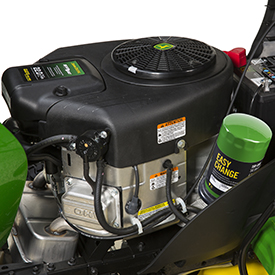 Oil filter
Oil filter
A 22-hp (16.4-kW) V-twin engine provides plenty of power and torque to handle tough mulching, mowing, and bagging conditions:
- V-twin cylinder design for greater torque, lower vibration, and improved sound quality
- Auto choke system to allow operators to start the engine without needing the choke unless air temperatures are near or below freezing
- Electronic ignition for fast starts
- Spring-return feature to ensure the operator will not mistakenly leave the throttle lever in the choke position
- Cast-iron cylinder liners for longer engine life
- Overhead valves for excellent power and fuel economy
- Full-pressure lubrication and oil filter for cleaner oil, prolonging engine life and extending the time between oil changes
- More effective when operating the tractor on an incline
- John Deere Easy Change™ 30-second oil change system makes changing the engine oil easy, quick, and clean.
Fuel tank has gauge to show fuel level from the operator's seat
 Fuel tank gauge
Fuel tank gauge
 Convenient fuel-filler opening
Convenient fuel-filler opening
The fuel tank gauge shows how much fuel is in the tank and can be seen without leaving the operator's seat:
- Easy to check fuel level
- Convenient location
Fuel tank:
- The capacity is 2.4 U.S. gal. (9.1 L).
- The fuel-filler opening is conveniently located under the seat.
- Filling the tank without spilling is easy.
- A tethered fuel tank cap is more convenient.
- The sealed fuel cap helps keep vapors inside the tank.
- The tractor has a California Air Resources Board (CARB) certified engine for reduced air pollution.
John Deere Easy Change™ 30-second oil change system
 John Deere Easy Change 30-second oil change system
John Deere Easy Change 30-second oil change system
The John Deere Easy Change 30-second oil change system makes changing the engine oil easy, quick, and clean. Changing the oil is as easy as twisting on a new oil-filled filter. Oil does not need to be drained from the engine.
The John Deere Easy Change filter is an additional engine oil reservoir. Changing the filter removes the captured contaminants and replaces about 0.8 qt (0.76 L) of the engine oil.
The functionality does not stop with ease of use. The Easy Change oil system has several meaningful benefits over the traditional oil filter system of the 100 Series:
- A synthetic filter material is used for more predictable filtering and longer life.
- Filtering capacity is greater than with a standard oil filter.
- More filter surface area
- More oil flow capacity
- The system has 40 percent more oil volume.
- The oil and engine run cooler.
- The oil filter valve closes whenever the engine stops, so filtered particles are captured and cannot drain back into the engine.
- The risk of spilling during oil service is greatly reduced.
- Waste oil (and new oil production) is reduced by over 1,000,000 lb (453,592.4 kg) per tractor production year.
- This system is not a compromise to just make oil changes easier—these engines pass the same expectations and rigorous testing as always.
Partly due to these improvements, it is not necessary to remove and dispose of all the oil in the engine during service.
Everyone who uses the John Deere Easy Change system saves time and avoids the mess of a traditional oil change. In the past, many 100 Series Lawn Tractor owners rarely or never got around to changing their engine oil. With John Deere Easy Change, even owners who previously would not consider changing the oil themselves can easily do it. The Easy Change 30-second oil change system is a no-mess, no-fuss solution the competition cannot match.
Installation instructions are in the Operator’s Manual and in the John Deere Easy Change service part box.
Please recycle. Many local government recycling programs, authorized retailers, auto-service centers, and auto-parts stores will puncture and recycle used oil filters and oil.
Frame made of full-length welded steel for reliability
 Solid one-piece frame
Solid one-piece frame
 Solid one-piece frame
Solid one-piece frame
The solid one-piece frame is constructed of 12-gauge, 0.105-in. (2.66-mm) steel:
- Full-length, robotically-welded frame design has high-strength steel rails for added strength and long life.
- One-piece, steel fender deck is bolted to the frame.
Cast-iron front axle will not bend
 Front axle and wheel spindle
Front axle and wheel spindle
The front axle is constructed of solid cast iron that will not bend:
- Automotive-like steering system with sector and pinion steering gears and single drag link with a tie rod provides a very strong, low-effort, and tight-turning system.
- Three grease fittings, on both steering spindles and center pivot, allow for regular lubrication to help maintain easy steering and minimize wear.
- Large, 0.75-in. (1.9-cm) diameter wheel spindles provide excellent durability.
CargO Mount™ system makes installation of rear bagger and other attachments easy
 Rear CargO Mount points
Rear CargO Mount points
 Front CargO Mount points
Front CargO Mount points
 Rear bagger is mounted with CargO Mount points
Rear bagger is mounted with CargO Mount points
 Rear bagger is mounted with CargO Mount points
Rear bagger is mounted with CargO Mount points
The CargO Mount system is a combination of front- and rear-mounting points providing convenient and easy installation of the sun canopy, rear bagger, and other attachments.
Snow removal is a strength of lawn tractors
 Snow blower, weather enclosure, weights, and chains on a 100 Series Tractor
Snow blower, weather enclosure, weights, and chains on a 100 Series Tractor
 Front blade, weather enclosure, and chains on a 100 Series Tractor
Front blade, weather enclosure, and chains on a 100 Series Tractor
An advantage of lawn tractors is their ability to use equipment for snow removal. Lawn tractor owners can add a John Deere snow blower or front blade to make quick work of moving snow whenever the need arises. Weather enclosure and tire-chain attachments add comfort and performance.
Equipment available for snow removal includes:
- 44-in. (112-cm) Snow Blower
- 46-in. (117-cm) Front Blade
- Tire chains or TerraGrip traction belts
- Weather enclosure
- Weights
Hydrostatic transmission gives an infinite choice of ground speeds
 Two-pedal speed/direction controls
Two-pedal speed/direction controls
 Forward speed control pedal in use
Forward speed control pedal in use
A Kanzaki® Tuff Torq® hydrostatic transmission gives an infinite choice of speeds and makes changing the direction of travel easy. Side-by-side foot pedals control the speed and direction of travel:
- Automotive-type accelerator controls ensure easy operation.
- Operator can change direction without lifting foot off the platform.
- Large pedal surface gives superior operator comfort.
 Hydrostatic transmission
Hydrostatic transmission
Appropriate transmissions are used in each model, depending on rear tire size and tractor performance requirements, to ensure excellent performance and reliability:
- Tuff Torq TLT200A - E110, E120, E130
- Tuff Torq TLT200B - E140, E150, E160
- Tuff Torq K46AC - E170, E180
Standard cruise control (E120, E130, E150, E160, E170, and E180)
 Cruise control lever
Cruise control lever
An easy-to-use cruise control option maintains the tractor's speed for mowing larger areas:
- To engage, lift up on the cruise lever and hold it until the foot is removed from the forward pedal.
- To disengage, lightly press and then release the forward pedal.
- For emergency stops, cruise can be released by pushing on the brake pedal or pushing down on the cruise control lever.
NOTE: Cruise control is available on all models except the E100, E110, and E140.
Kanzaki and Tuff Torq are trademarks of Kanzaki Kokyukoki Manufacturing Company.
Operator station designed for comfortable operation
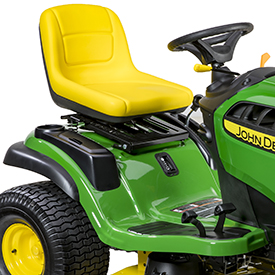 Comfortable operator station
Comfortable operator station
 Comfortable operator station
Comfortable operator station
The operator station is designed for operator comfort and easy operation:
- Controls are positioned where they are easy to reach and use to control the tractor.
- The steering wheel is positioned and angled to give the operator plenty of room and steering comfort.
- The seat is tilted back at the optimum angle to provide the most comfortable operator position.
 Steering wheel and dash
Steering wheel and dash
 Wide footrest with debris channels
Wide footrest with debris channels
Controls are easy to see and use:
- Large, three-spoke steering wheel for greater operator comfort and control
- Ignition switch is on the dash for starting ease
Wide footrest areas with non-slip, anti-vibration floor mats are provided for operator comfort:
- Debris removing channels help keep the footrest area clean and dry.
- The wide footrest makes it easier to step over the mower deck while entering or exiting the seat.
 High-back seat mounted on adjustable suspension
High-back seat mounted on adjustable suspension
 Easy-to-adjust seat
Easy-to-adjust seat
The operator seat has a 15-in. (38.1-cm) back height for good support. It is especially helpful when operating the tractor for extended periods of time.
It can be easily adjusted forward or rearward while in the seat, with seat travel of 5.5 in. (14 cm) and 10 different positions.
 Seat springs give a smoother ride
Seat springs give a smoother ride
 Seat tilted forward (shown on E180 Tractor)
Seat tilted forward (shown on E180 Tractor)
Two long seat springs give plenty of seat travel to smooth out the ride, keeping the operator comfortable while operating the tractor.
The seat can be tilted forward for protection from the elements and to provide easy access to the fuel tank.
 Beverage holder
Beverage holder
 Storage compartment
Storage compartment
A beverage holder and storage compartment, located on the right side fender, are conveniently located and easy to use.
Fender flares cover the tires more completely and add style to the tractor.
Instruments and controls are easy to find and convenient to use
 E160 Tractor mowing
E160 Tractor mowing
 Steering wheel and controls
Steering wheel and controls
Instruments and controls
The contoured dash has clean, attractive styling:
-
Controls are color coded and labeled for easy identification by the operator.
-
Controls are logically placed and easy to reach.
-
The hour meter makes it easy to tell when oil changes and other maintenance should be performed.
- A service reminder feature will indicate that a general lubrication or mower/engine service interval has been reached.
- When service is required, arrows will periodically flash for two hours.
-
Functional design of the controls provides good appearance and a comfortable feel.
Side-by-side transmission control pedals
 Two-pedal speed/direction controls
Two-pedal speed/direction controls
 Side-by-side foot pedals and cruise control lever
Side-by-side foot pedals and cruise control lever
Side-by-side foot pedals control the speed and direction of travel:
- Automotive-type accelerator controls ensure easy operation.
- Operator can change direction without lifting foot off the platform.
- Large pedal surface gives superior operator comfort.
Cruise control (E120, E130, E150, E160, E170, and E180)
 Cruise control lever
Cruise control lever
Cruise control is available on the E120, E130, E150, E160, E170, and the E180:
- To engage, lift up on the cruise lever and hold until the foot is removed from the forward pedal.
- For emergency stop, the cruise control can be released by pushing on the brake pedal or the forward pedal.
Mower deck height adjustment
 Mower deck height adjustment lever
Mower deck height adjustment lever
 Mower deck height adjustment lever
Mower deck height adjustment lever
A spring-assisted, low-effort lift lever simplifies setting and adjusting the mower cut height:
-
Increments of 0.25 in. (0.64 cm) allow fine-tuning the cut height.
-
Cut height is adjustable from 1 in. (2.5 cm) to 4 in. (10.2 cm).
Parking brake control
 Brake/parking brake pedal
Brake/parking brake pedal
 Parking brake lever
Parking brake lever
The parking brake control is conveniently located for easy access. It holds the brake pedal securely in the locked position.
Electric power take-off (PTO) clutch is easy and convenient to use
 Electric PTO engagement switch
Electric PTO engagement switch
The heavy-duty electric PTO clutch is operated with a convenient dash-mounted switch.
Reverse implement option (RIO)
 RIO switch
RIO switch
Using RIO
CAUTION: Children or bystanders may be injured by rotating blades. Before traveling forward or rearward:
- Carefully check the area around the machine.
- Disengage the mower before backing up.
NOTE: Backing up while the mower is engaged is strongly discouraged. RIO should be used only when operating another attachment or when the operator deems it necessary to reposition the machine with the mower engaged.
- Stop forward travel.
- Look behind the machine to be sure there are no bystanders.
- Push and hold in the RIO switch while depressing the reverse pedal slightly for a hydrostatic transmission or moving the transmission shift lever to the rear slot (reverse) for a continuously variable transmission (CVT)/automatic transmission.
NOTE: If the engine and mower or other attachment stops while repositioning the machine, return the attachment engagement lever/switch to the off position. Start the engine and engage mower or other attachment. Begin again with step 2.
- Release the RIO switch and reposition the machine as the machine begins to move rearward.
- Resume forward travel. The mower or other attachment should continue operating.
- Repeat procedure to position the machine again.
Serviceability is convenient with easy-open hood
 One-piece hood is easy to open
One-piece hood is easy to open
 Service interval decal located under hood
Service interval decal located under hood
The one-piece hood opens easily to permit checking and servicing the engine:
- Important service points are located within easy reach.
- A service-interval decal is provided inside the tractor hood for convenience when servicing the tractor.
 John Deere Easy Change™ 30-second oil change system
John Deere Easy Change™ 30-second oil change system
 Seat tilted up for easy access to fuel-fill opening
Seat tilted up for easy access to fuel-fill opening
The John Deere Easy Change 30-second oil change system makes changing the engine oil easy, quick, and clean. Changing the oil is as easy as removing the old oil-filled filter and twisting on a new oil-filled filter. Oil does not need to be drained from the engine. The removed filter contains the captured contaminants and a portion of the engine oil.
The seat tilts up and out of the way to make adding fuel easy.
The 100 Series Tractors are covered by a 2-year/120-hour bumper-to-bumper warranty*:
- Premium features of 100 Series Tractors allow for this long warranty period.
*Term limited to years or hours used, whichever comes first, and varies by model. See the LIMITED WARRANTY FOR NEW JOHN DEERE TURF AND UTILITY EQUIPMENT at JohnDeere.com or JohnDeere.ca/TUWarranty for details.
Hood will not dent or rust and includes quality headlights for good visibility
 One-piece hood opens for service access
One-piece hood opens for service access
 Quality headlights for good visibility
Quality headlights for good visibility
The hood is made of molded-in color material:
- Reduces sound
- Will not rust or dent
- Openings on the side of the hood let in plenty of cooling air while keeping the sound level low.
- Two headlights provide good lighting for nighttime operation.
The MowerPlus™ app helps maintain the tractor and lawn
 MowerPlus app screen
MowerPlus app screen
 MowerPlus app maintenance screen
MowerPlus app maintenance screen
Keep a John Deere riding lawn mower running its best and know how it mows with the John Deere MowerPlus app. Simply scan the lawn tractor’s barcode to get custom information. The app helps determine the best time to mow, communicates expert pre-mow tips, offers maintenance reminders, and provides walk-through guides.
Look for the MowerPlus app on the iOS® or Android™ system app stores.
The app supports residential lawn equipment such as 100 Series, S240, X300, X500, X700, Z200 through Z600, and many similarly-sized older products. It does not presently support tractor models numbered 1000 and larger, such as 1025R.
NOTE: Some product image variation may exist.
MowerPlus hour meter connector also available (sold separately)
 MowerPlus hour meter connector packaging
MowerPlus hour meter connector packaging
The John Deere MowerPlus hour meter connector wirelessly links a 100 Series or S240 Lawn Tractor to the MowerPlus app on a mobile device. The hour meter connector transmits engine usage to the app, making it easy to track maintenance intervals:
- iOS version 10 or higher is compatible with the hour meter connector.
- Android versions are not compatible with the hour meter connector at this time.
iOS is a trademark of Cisco Technology, Inc. used under license by Apple Inc. Android is a trademark of Google LLC.
The Edge™ cutting system gives superior performance
 E160 Tractor with 48-in. (122-cm) Edge cutting system
E160 Tractor with 48-in. (122-cm) Edge cutting system
 48-in. (122-cm) Edge cutting system
48-in. (122-cm) Edge cutting system

The Edge cutting system has been trademarked to emphasize the advantages of the John Deere mower deck designs. They give superior convenience, performance, and reliability:
- Deep-deck mower design lifts grass for a clean, even cut.
- Smooth underside of mower prevents grass buildup and evenly disperses grass clippings.
- The rolled outer edge of the deck provides extra strength and protection.
- Dual-stage E-coat and powder paint coatings provide extra protection from rust.
The 48-in. (121.9-cm) Edge mower deck is a three-spindle design with heavy-duty characteristics:
- Four mower wheels are standard equipment for a smooth mowing job, even in rolling terrain.
- Flexible discharge chute minimizes property and mower deck damage.
- No tools are required to go from mulching (with mulch cover) to side discharge to rear bagging.
- A mulch cover is an optional attachment that can be installed without the use of tools.
- A high-performance mulching blade (GX21786) is available to enhance mulching performance.
- Bagging blades are available to improve bagging performance.
The mower deck has a rolled lip to provide greater strength and protection. The rugged 12-gauge, 0.105-in. (2.7-mm) steel-deck mower will provide years of dependable mowing.
The blade-to-spindle design provides a unique mounting system for the mower blade that gives extra safety and convenience.
A cut-and-throw, 6.5-bu (229-L) rear bagger is sold separately and comes with bagging blades.
Mower wash port
 Mower wash port
Mower wash port
 Mower wash port with hose connector
Mower wash port with hose connector
A wash port is provided to make cleaning the underside of the mower deck easy:
-
A hose connector is included with mower deck.
StarLock™ blade design
 StarLock blade design
StarLock blade design
The StarLock blade design keeps the blade bolt at the correct torque for easy removal.
Optional blades for difficult mulching or bagging conditions are available.
Mower deck height adjustment
 Mower deck height adjustment lever
Mower deck height adjustment lever
 Mower deck height adjustment lever
Mower deck height adjustment lever
A spring-assisted, low-effort lift lever simplifies setting and adjusting the mower cut height:
- Increments of 0.25 in. (0.64 cm) allow the operator to fine-tune the cut height.
- Cut height is adjustable from 1 in. (2.5 cm) to 4 in. (10.2 cm).
- The lift handle is shaped and located for easy use and is out of the way of entering or exiting operators.
Two-year or 120-hour bumper-to-bumper warranty is standard
An exclusive 2-year or 120-hour (whichever comes first), single-source, bumper-to-bumper warranty* is standard for all John Deere 100 Series Tractors.
- The warranty is hassle free, with one company handling all of the paperwork.
- Premium features of 100 Series Tractors allow for this longer warranty period, with more coverage than comparable tractors.
*Term limited to years or hours used, whichever comes first, and varies by model. See the LIMITED WARRANTY FOR NEW JOHN DEERE TURF AND UTILITY EQUIPMENT at JohnDeere.com or JohnDeere.ca/TUWarranty for details.
Features
Engine is powerful and smooth-running V-twin design
 22-hp (16.4-kW) engine
22-hp (16.4-kW) engine
 Oil filter and fuel filter
Oil filter and fuel filter
A 22-hp (16.4-kW) V-twin engine provides plenty of power and torque to handle tough mulching, mowing, and bagging conditions:
- V-twin cylinder design for greater torque, lower vibration, and improved sound quality
- Electronic ignition for fast starts
- Spring-return feature to ensure the operator will not mistakenly leave the throttle lever in the choke position
- Cast-iron cylinder liners for longer engine life
- Overhead valves for excellent power and fuel economy
- Full-pressure lubrication and oil filter for cleaner oil, prolonging engine life and extending the time between oil changes
- More effective when operating the tractor on an incline
Fuel tank has gauge to show fuel level from the operator's seat
 Fuel tank gauge
Fuel tank gauge
 Convenient fuel-filler opening
Convenient fuel-filler opening
The fuel tank gauge shows how much fuel is in the tank and can be seen without leaving the operator's seat:
- Easy to check fuel level
- Convenient location
Fuel tank:
- The capacity is 2.4 U.S. gal. (9.1 L).
- The fuel-filler opening is conveniently located under the seat.
- Filling the tank without spilling is easy.
- A tethered fuel tank cap is more convenient.
- The sealed fuel cap helps keep vapors inside the tank.
- The tractor has a California Air Resources Board (CARB) certified engine for reduced air pollution.
Frame made of full-length welded steel for reliability
 Solid one-piece frame
Solid one-piece frame
 Solid one-piece frame
Solid one-piece frame
The solid one-piece frame is constructed of 12-gauge, 0.105-in. (2.66-mm) steel:
- Full-length, robotically-welded frame design has high-strength steel rails for added strength and long life.
- One-piece, steel fender deck is bolted to the frame.
Cast-iron front axle will not bend
 Front axle and wheel spindle
Front axle and wheel spindle
The front axle is constructed of solid cast iron that will not bend:
- Automotive-like steering system with sector and pinion steering gears and single drag link with a tie rod provides a very strong, low-effort, and tight-turning system.
- Three grease fittings, on both steering spindles and center pivot, allow for regular lubrication to help maintain easy steering and minimize wear.
- Large, 0.75-in. (1.9-cm) diameter wheel spindles provide excellent durability.
CargO Mount™ system makes installation of rear bagger and other attachments easy
 Rear CargO Mount points
Rear CargO Mount points
 Front CargO Mount points
Front CargO Mount points
 Rear bagger is mounted with CargO Mount points
Rear bagger is mounted with CargO Mount points
 Rear bagger is mounted with CargO Mount points
Rear bagger is mounted with CargO Mount points
The CargO Mount system is a combination of front- and rear-mounting points providing convenient and easy installation of the sun canopy, rear bagger, and other attachments.
Snow removal is a strength of lawn tractors
 Snow blower, weather enclosure, weights, and chains on a 100 Series Tractor
Snow blower, weather enclosure, weights, and chains on a 100 Series Tractor
 Front blade, weather enclosure, and chains on a 100 Series Tractor
Front blade, weather enclosure, and chains on a 100 Series Tractor
An advantage of lawn tractors is their ability to use equipment for snow removal. Lawn tractor owners can add a John Deere snow blower or front blade to make quick work of moving snow whenever the need arises. Weather enclosure and tire-chain attachments add comfort and performance.
Equipment available for snow removal includes:
- 44-in. (112-cm) Snow Blower
- 46-in. (117-cm) Front Blade
- Tire chains or TerraGrip traction belts
- Weather enclosure
- Weights
Hydrostatic transmission gives an infinite choice of ground speeds
 Two-pedal speed/direction controls
Two-pedal speed/direction controls
 Forward speed control pedal in use
Forward speed control pedal in use
A Kanzaki® Tuff Torq® hydrostatic transmission gives an infinite choice of speeds and makes changing the direction of travel easy. Side-by-side foot pedals control the speed and direction of travel:
- Automotive-type accelerator controls ensure easy operation.
- Operator can change direction without lifting foot off the platform.
- Large pedal surface gives superior operator comfort.
 Hydrostatic transmission
Hydrostatic transmission
Appropriate transmissions are used in each model, depending on rear tire size and tractor performance requirements, to ensure excellent performance and reliability:
- Tuff Torq TLT200A - E110, E120, E130
- Tuff Torq TLT200B - E140, E150, E160
- Tuff Torq K46AC - E170, E180
Standard cruise control (E120, E130, E150, E160, E170, and E180)
 Cruise control lever
Cruise control lever
An easy-to-use cruise control option maintains the tractor's speed for mowing larger areas:
- To engage, lift up on the cruise lever and hold it until the foot is removed from the forward pedal.
- To disengage, lightly press and then release the forward pedal.
- For emergency stops, cruise can be released by pushing on the brake pedal or pushing down on the cruise control lever.
NOTE: Cruise control is available on all models except the E100, E110, and E140.
Kanzaki and Tuff Torq are trademarks of Kanzaki Kokyukoki Manufacturing Company.
Operator station designed for comfortable operation
 Comfortable operator station, right side
Comfortable operator station, right side
 Comfortable operator station, left side
Comfortable operator station, left side
The operator station is designed for operator comfort and easy operation:
- Controls are positioned where they are easy to reach and use to control the tractor.
- The steering wheel is positioned and angled to give the operator plenty of room and steering comfort.
- The seat is tilted back at the optimum angle to provide the most comfortable operator position.
 Steering wheel and dash
Steering wheel and dash
 Wide footrest with debris-removal channels
Wide footrest with debris-removal channels
Controls are easy to see and use:
- Large, three-spoke steering wheel for greater operator comfort and control
- Ignition switch is on the dash for starting ease
Wide footrest areas with non-slip, anti-vibration floor mats are provided for operator comfort:
- Debris removing channels help keep the footrest area clean and dry
- The wide footrest makes it easier to step over the mower deck while entering or exiting the seat.
 Comfortable seat
Comfortable seat
 Easily-adjusted seat
Easily-adjusted seat
The operator seat has a 15-in. (38.1-cm) back height for good support. It is especially helpful when operating the tractor for extended periods of time. It can be easily adjusted forward or rearward while in the seat, with seat travel of 5.5 in. (14 cm) and 10 different positions.
 Seat springs give a smoother ride
Seat springs give a smoother ride
 Seat tilted forward (shown on E180 Tractor)
Seat tilted forward (shown on E180 Tractor)
Two long seat springs give plenty of seat travel to smooth out the ride, keeping the operator comfortable while operating the tractor.
The seat can be tilted forward for protection from the elements and to provide easy access to the fuel tank.
 Storage compartment (shown with optional cover)
Storage compartment (shown with optional cover)
 Beverage holder (optional storage compartment cover shown)
Beverage holder (optional storage compartment cover shown)
A storage compartment and beverage holder, located on the right-side fender, are conveniently located and easy to use.
NOTE: A storage compartment cover is standard on E120, E130, E150, E160, E170 and E180 Tractors and optional on the E110 and E140.
Instruments and controls are easy to find and convenient to use
 E160 Tractor mowing
E160 Tractor mowing
 Steering wheel and controls
Steering wheel and controls
Instruments and controls
The contoured dash has clean, attractive styling:
-
Controls are color coded and labeled for easy identification by the operator.
-
Controls are logically placed and easy to reach.
-
The hour meter makes it easy to tell when oil changes and other maintenance should be performed.
- A service reminder feature will indicate that a general lubrication or mower/engine service interval has been reached.
- When service is required, arrows will periodically flash for two hours.
-
Functional design of the controls provides good appearance and a comfortable feel.
Side-by-side transmission control pedals
 Two-pedal speed/direction controls
Two-pedal speed/direction controls
 Side-by-side foot pedals and cruise control lever
Side-by-side foot pedals and cruise control lever
Side-by-side foot pedals control the speed and direction of travel:
- Automotive-type accelerator controls ensure easy operation.
- Operator can change direction without lifting foot off the platform.
- Large pedal surface gives superior operator comfort.
Cruise control (E120, E130, E150, E160, E170, and E180)
 Cruise control lever
Cruise control lever
Cruise control is available on the E120, E130, E150, E160, E170, and the E180:
- To engage, lift up on the cruise lever and hold until the foot is removed from the forward pedal.
- For emergency stop, the cruise control can be released by pushing on the brake pedal or the forward pedal.
Mower deck height adjustment
 Mower deck height adjustment lever
Mower deck height adjustment lever
 Mower deck height adjustment lever
Mower deck height adjustment lever
A spring-assisted, low-effort lift lever simplifies setting and adjusting the mower cut height:
-
Increments of 0.25 in. (0.64 cm) allow fine-tuning the cut height.
-
Cut height is adjustable from 1 in. (2.5 cm) to 4 in. (10.2 cm).
Parking brake control
 Brake/parking brake pedal
Brake/parking brake pedal
 Parking brake lever
Parking brake lever
The parking brake control is conveniently located for easy access. It holds the brake pedal securely in the locked position.
Electric power take-off (PTO) clutch is easy and convenient to use
 Electric PTO engagement switch
Electric PTO engagement switch
The heavy-duty electric PTO clutch is operated with a convenient dash-mounted switch.
Reverse implement option (RIO)
 RIO switch
RIO switch
Using RIO
CAUTION: Children or bystanders may be injured by rotating blades. Before traveling forward or rearward:
- Carefully check the area around the machine.
- Disengage the mower before backing up.
NOTE: Backing up while the mower is engaged is strongly discouraged. RIO should be used only when operating another attachment or when the operator deems it necessary to reposition the machine with the mower engaged.
- Stop forward travel.
- Look behind the machine to be sure there are no bystanders.
- Push and hold in the RIO switch while depressing the reverse pedal slightly for a hydrostatic transmission or moving the transmission shift lever to the rear slot (reverse) for a continuously variable transmission (CVT)/automatic transmission.
NOTE: If the engine and mower or other attachment stops while repositioning the machine, return the attachment engagement lever/switch to the off position. Start the engine and engage mower or other attachment. Begin again with step 2.
- Release the RIO switch and reposition the machine as the machine begins to move rearward.
- Resume forward travel. The mower or other attachment should continue operating.
- Repeat procedure to position the machine again.
Serviceability is convenient with an easy-open hood
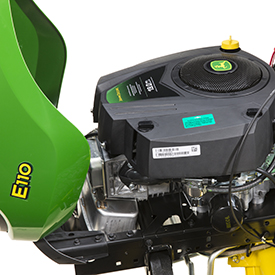 One-piece hood is easy to open
One-piece hood is easy to open
 Service interval decal located under hood
Service interval decal located under hood
The one-piece hood opens easily to permit checking and servicing the engine:
- Important service points are located within easy reach.
- A service interval decal is provided inside the tractor hood for convenience when servicing the tractor.
- Hour meter includes a service reminder feature that flashes for two hours when a lubrication or mower/engine service interval has been reached.
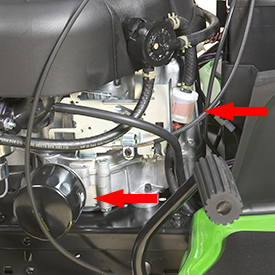 Easy-to-service engine fuel and oil filters
Easy-to-service engine fuel and oil filters
 Seat tilted up for easy access to fuel-fill opening
Seat tilted up for easy access to fuel-fill opening
The engine fuel and oil filters, the oil check/fill tube, and the oil drain tube are exposed for serviceability when the hood is opened.
The seat tilts up and out of the way to make adding fuel easy.
The 100 Series Tractors are covered by a 2-year/120-hour bumper-to-bumper warranty*:
- Premium features of 100 Series Tractors allow for this long warranty period.
*Term limited to years or hours used, whichever comes first, and varies by model. See the LIMITED WARRANTY FOR NEW JOHN DEERE TURF AND UTILITY EQUIPMENT at JohnDeere.com or JohnDeere.ca/TUWarranty for details.
Hood will not dent or rust and includes quality headlights for good visibility
 One-piece hood opens for service access
One-piece hood opens for service access
 Quality headlights for good visibility
Quality headlights for good visibility
The hood is made of molded-in color material:
- Reduces sound
- Will not rust or dent
- Openings on the side of the hood let in plenty of cooling air while keeping the sound level low.
- Two headlights provide good lighting for nighttime operation.
The MowerPlus™ app helps maintain the tractor and lawn
 MowerPlus app screen
MowerPlus app screen
 MowerPlus app maintenance screen
MowerPlus app maintenance screen
Keep a John Deere riding lawn mower running its best and know how it mows with the John Deere MowerPlus app. Simply scan the lawn tractor’s barcode to get custom information. The app helps determine the best time to mow, communicates expert pre-mow tips, offers maintenance reminders, and provides walk-through guides.
Look for the MowerPlus app on the iOS® or Android™ system app stores.
The app supports residential lawn equipment such as 100 Series, S240, X300, X500, X700, Z200 through Z600, and many similarly-sized older products. It does not presently support tractor models numbered 1000 and larger, such as 1025R.
NOTE: Some product image variation may exist.
MowerPlus hour meter connector also available (sold separately)
 MowerPlus hour meter connector packaging
MowerPlus hour meter connector packaging
The John Deere MowerPlus hour meter connector wirelessly links a 100 Series or S240 Lawn Tractor to the MowerPlus app on a mobile device. The hour meter connector transmits engine usage to the app, making it easy to track maintenance intervals:
- iOS version 10 or higher is compatible with the hour meter connector.
- Android versions are not compatible with the hour meter connector at this time.
iOS is a trademark of Cisco Technology, Inc. used under license by Apple Inc. Android is a trademark of Google LLC.
The Edge™ cutting system gives superior performance
 E160 Tractor with 48-in. (122-cm) Edge cutting system
E160 Tractor with 48-in. (122-cm) Edge cutting system
 48-in. (122-cm) Edge cutting system
48-in. (122-cm) Edge cutting system

The Edge cutting system has been trademarked to emphasize the advantages of the John Deere mower deck designs. They give superior convenience, performance, and reliability:
- Deep-deck mower design lifts grass for a clean, even cut.
- Smooth underside of mower prevents grass buildup and evenly disperses grass clippings.
- The rolled outer edge of the deck provides extra strength and protection.
- Dual-stage E-coat and powder paint coatings provide extra protection from rust.
The 48-in. (121.9-cm) Edge mower deck is a three-spindle design with heavy-duty characteristics:
- Four mower wheels are standard equipment for a smooth mowing job, even in rolling terrain.
- Flexible discharge chute minimizes property and mower deck damage.
- No tools are required to go from mulching (with mulch cover) to side discharge to rear bagging.
- A mulch cover is an optional attachment that can be installed without the use of tools.
- A high-performance mulching blade (GX21786) is available to enhance mulching performance.
- Bagging blades are available to improve bagging performance.
The mower deck has a rolled lip to provide greater strength and protection. The rugged 12-gauge, 0.105-in. (2.7-mm) steel-deck mower will provide years of dependable mowing.
The blade-to-spindle design provides a unique mounting system for the mower blade that gives extra safety and convenience.
A cut-and-throw, 6.5-bu (229-L) rear bagger is sold separately and comes with bagging blades.
Mower wash port
 Mower wash port
Mower wash port
 Mower wash port with hose connector
Mower wash port with hose connector
A wash port is provided to make cleaning the underside of the mower deck easy:
-
A hose connector is included with mower deck.
StarLock™ blade design
 StarLock blade design
StarLock blade design
The StarLock blade design keeps the blade bolt at the correct torque for easy removal.
Optional blades for difficult mulching or bagging conditions are available.
Mower deck height adjustment
 Mower deck height adjustment lever
Mower deck height adjustment lever
 Mower deck height adjustment lever
Mower deck height adjustment lever
A spring-assisted, low-effort lift lever simplifies setting and adjusting the mower cut height:
- Increments of 0.25 in. (0.64 cm) allow the operator to fine-tune the cut height.
- Cut height is adjustable from 1 in. (2.5 cm) to 4 in. (10.2 cm).
- The lift handle is shaped and located for easy use and is out of the way of entering or exiting operators.
Two-year or 120-hour bumper-to-bumper warranty is standard
An exclusive 2-year or 120-hour (whichever comes first), single-source, bumper-to-bumper warranty* is standard for all John Deere 100 Series Tractors.
- The warranty is hassle free, with one company handling all of the paperwork.
- Premium features of 100 Series Tractors allow for this longer warranty period, with more coverage than comparable tractors.
*Term limited to years or hours used, whichever comes first, and varies by model. See the LIMITED WARRANTY FOR NEW JOHN DEERE TURF AND UTILITY EQUIPMENT at JohnDeere.com or JohnDeere.ca/TUWarranty for details.
Features
Engine is powerful and smooth-running V-twin design
 22-hp (16.4-kW) engine
22-hp (16.4-kW) engine
 Oil filter
Oil filter
A 22-hp (16.4-kW) V-twin engine provides plenty of power and torque to handle tough mulching, mowing, and bagging conditions:
- V-twin cylinder design for greater torque, lower vibration, and improved sound quality
- Auto choke system to allow operators to start the engine without needing the choke unless air temperatures are near or below freezing
- Electronic ignition for fast starts
- Spring-return feature to ensure the operator will not mistakenly leave the throttle lever in the choke position
- Cast-iron cylinder liners for longer engine life
- Overhead valves for excellent power and fuel economy
- Full-pressure lubrication and oil filter for cleaner oil, prolonging engine life and extending the time between oil changes
- More effective when operating the tractor on an incline
- John Deere Easy Change™ 30-second oil change system makes changing the engine oil easy, quick, and clean.
Fuel tank has gauge to show fuel level from the operator's seat
 Fuel tank gauge
Fuel tank gauge
 Convenient fuel-filler opening
Convenient fuel-filler opening
The fuel tank gauge shows how much fuel is in the tank and can be seen without leaving the operator's seat:
- Easy to check fuel level
- Convenient location
Fuel tank:
- The capacity is 2.4 U.S. gal. (9.1 L).
- The fuel-filler opening is conveniently located under the seat.
- Filling the tank without spilling is easy.
- A tethered fuel tank cap is more convenient.
- The sealed fuel cap helps keep vapors inside the tank.
- The tractor has a California Air Resources Board (CARB) certified engine for reduced air pollution.
John Deere Easy Change™ 30-second oil change system
 John Deere Easy Change 30-second oil change system
John Deere Easy Change 30-second oil change system
The John Deere Easy Change 30-second oil change system makes changing the engine oil easy, quick, and clean. Changing the oil is as easy as twisting on a new oil-filled filter. Oil does not need to be drained from the engine.
The John Deere Easy Change filter is an additional engine oil reservoir. Changing the filter removes the captured contaminants and replaces about 0.8 qt (0.76 L) of the engine oil.
The functionality does not stop with ease of use. The Easy Change oil system has several meaningful benefits over the traditional oil filter system of the 100 Series:
- A synthetic filter material is used for more predictable filtering and longer life.
- Filtering capacity is greater than with a standard oil filter.
- More filter surface area
- More oil flow capacity
- The system has 40 percent more oil volume.
- The oil and engine run cooler.
- The oil filter valve closes whenever the engine stops, so filtered particles are captured and cannot drain back into the engine.
- The risk of spilling during oil service is greatly reduced.
- Waste oil (and new oil production) is reduced by over 1,000,000 lb (453,592.4 kg) per tractor production year.
- This system is not a compromise to just make oil changes easier—these engines pass the same expectations and rigorous testing as always.
Partly due to these improvements, it is not necessary to remove and dispose of all the oil in the engine during service.
Everyone who uses the John Deere Easy Change system saves time and avoids the mess of a traditional oil change. In the past, many 100 Series Lawn Tractor owners rarely or never got around to changing their engine oil. With John Deere Easy Change, even owners who previously would not consider changing the oil themselves can easily do it. The Easy Change 30-second oil change system is a no-mess, no-fuss solution the competition cannot match.
Installation instructions are in the Operator’s Manual and in the John Deere Easy Change service part box.
Please recycle. Many local government recycling programs, authorized retailers, auto-service centers, and auto-parts stores will puncture and recycle used oil filters and oil.
Frame made of full-length welded steel for reliability
 Solid one-piece frame
Solid one-piece frame
 Solid one-piece frame
Solid one-piece frame
The solid one-piece frame is constructed of 12-gauge, 0.105-in. (2.66-mm) steel:
- Full-length, robotically-welded frame design has high-strength steel rails for added strength and long life.
- One-piece, steel fender deck is bolted to the frame.
Cast-iron front axle will not bend
 Front axle and wheel spindle
Front axle and wheel spindle
The front axle is constructed of solid cast iron that will not bend:
- Automotive-like steering system with sector and pinion steering gears and single drag link with a tie rod provides a very strong, low-effort, and tight-turning system.
- Three grease fittings, on both steering spindles and center pivot, allow for regular lubrication to help maintain easy steering and minimize wear.
- Large, 0.75-in. (1.9-cm) diameter wheel spindles provide excellent durability.
CargO Mount™ system makes installation of rear bagger and other attachments easy
 Rear CargO Mount points
Rear CargO Mount points
 Front CargO Mount points
Front CargO Mount points
 Rear bagger is mounted with CargO Mount points
Rear bagger is mounted with CargO Mount points
 Rear bagger is mounted with CargO Mount points
Rear bagger is mounted with CargO Mount points
The CargO Mount system is a combination of front- and rear-mounting points providing convenient and easy installation of the sun canopy, rear bagger, and other attachments.
Snow removal is a strength of lawn tractors
 Snow blower, weather enclosure, weights, and chains on a 100 Series Tractor
Snow blower, weather enclosure, weights, and chains on a 100 Series Tractor
 Front blade, weather enclosure, and chains on a 100 Series Tractor
Front blade, weather enclosure, and chains on a 100 Series Tractor
An advantage of lawn tractors is their ability to use equipment for snow removal. Lawn tractor owners can add a John Deere snow blower or front blade to make quick work of moving snow whenever the need arises. Weather enclosure and tire-chain attachments add comfort and performance.
Equipment available for snow removal includes:
- 44-in. (112-cm) Snow Blower
- 46-in. (117-cm) Front Blade
- Tire chains or TerraGrip traction belts
- Weather enclosure
- Weights
Hydrostatic transmission gives an infinite choice of ground speeds
 Two-pedal speed/direction controls
Two-pedal speed/direction controls
 Forward speed control pedal in use
Forward speed control pedal in use
A Kanzaki® Tuff Torq® hydrostatic transmission gives an infinite choice of speeds and makes changing the direction of travel easy. Side-by-side foot pedals control the speed and direction of travel:
- Automotive-type accelerator controls ensure easy operation.
- Operator can change direction without lifting foot off the platform.
- Large pedal surface gives superior operator comfort.
 Hydrostatic transmission
Hydrostatic transmission
Appropriate transmissions are used in each model, depending on rear tire size and tractor performance requirements, to ensure excellent performance and reliability:
- Tuff Torq TLT200A - E110, E120, E130
- Tuff Torq TLT200B - E140, E150, E160
- Tuff Torq K46AC - E170, E180
Standard cruise control (E120, E130, E150, E160, E170, and E180)
 Cruise control lever
Cruise control lever
An easy-to-use cruise control option maintains the tractor's speed for mowing larger areas:
- To engage, lift up on the cruise lever and hold it until the foot is removed from the forward pedal.
- To disengage, lightly press and then release the forward pedal.
- For emergency stops, cruise can be released by pushing on the brake pedal or pushing down on the cruise control lever.
NOTE: Cruise control is available on all models except the E100, E110, and E140.
Kanzaki and Tuff Torq are trademarks of Kanzaki Kokyukoki Manufacturing Company.
Operator station designed for comfortable operation
 Comfortable operator station
Comfortable operator station
 Comfortable operator station
Comfortable operator station
The operator station is designed for operator comfort and easy operation:
- Controls are positioned where they are easy to reach and use to control the tractor.
- The steering wheel is positioned and angled to give the operator plenty of room and steering comfort.
- The seat is tilted back at the optimum angle to provide the most comfortable operator position.
 Steering wheel and dash
Steering wheel and dash
 Wide footrest with debris channels
Wide footrest with debris channels
Controls are easy to see and use:
- Large, three-spoke steering wheel for greater operator comfort and control
- Ignition switch is on the dash for starting ease
Wide footrest areas with non-slip, anti-vibration floor mats are provided for operator comfort:
- Debris removing channels help keep the footrest area clean and dry.
- The wide footrest makes it easier to step over the mower deck while entering or exiting the seat.
 High-back seat mounted on adjustable suspension
High-back seat mounted on adjustable suspension
 Easy-to-adjust seat
Easy-to-adjust seat
The operator seat has a 15-in. (38.1-cm) back height for good support. It is especially helpful when operating the tractor for extended periods of time.
It can be easily adjusted forward or rearward while in the seat, with seat travel of 5.5 in. (14 cm) and 10 different positions.
 Seat springs give a smoother ride
Seat springs give a smoother ride
 Seat tilted forward (shown on E180 Tractor)
Seat tilted forward (shown on E180 Tractor)
Two long seat springs give plenty of seat travel to smooth out the ride, keeping the operator comfortable while operating the tractor.
The seat can be tilted forward for protection from the elements and to provide easy access to the fuel tank.
 Beverage holder
Beverage holder
 Storage compartment
Storage compartment
A beverage holder and storage compartment, located on the right side fender, are conveniently located and easy to use.
Fender flares cover the tires more completely and add style to the tractor.
Instruments and controls are easy to find and convenient to use
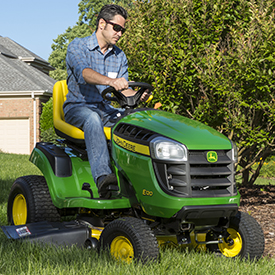 E120 Tractor mowing
E120 Tractor mowing
 Steering wheel and controls
Steering wheel and controls
Instruments and controls
The contoured dash has clean, attractive styling:
-
Controls are color coded and labeled for easy identification by the operator.
-
Controls are logically placed and easy to reach.
-
The hour meter makes it easy to tell when oil changes and other maintenance should be performed.
-
The service reminder feature will indicate that a general lubrication or mower/engine service interval has been reached.
-
When service is required, arrows will periodically flash for two hours.
-
Functional design of the controls provides good appearance and a comfortable feel.
Side-by-side transmission control pedals
 Hydro/automatic two-pedal speed/direction controls
Hydro/automatic two-pedal speed/direction controls
 Side-by-side foot pedals and cruise control lever
Side-by-side foot pedals and cruise control lever
Side-by-side foot pedals control the speed and direction of travel:
- Automotive-type accelerator controls ensure easy operation.
- Operator can change direction without lifting foot off the platform.
- Large pedal surface gives superior operator comfort.
Cruise control (E120, E130, E150, E160, E170, and E180)
 Cruise control lever
Cruise control lever
Cruise control is available on the E120, E130, E150, E160, E170, and E180:
- To engage, lift up on the cruise lever and hold until the foot is removed from the forward pedal.
- For emergency stop, the cruise control can be released by pushing on the brake pedal or the forward pedal.
Mower deck height adjustment
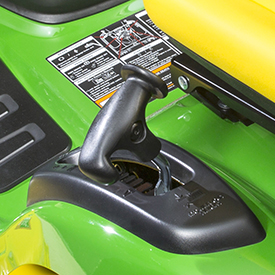 Mower deck height-adjustment lever
Mower deck height-adjustment lever
A spring-assisted, low-effort lift lever simplifies setting and adjusting the mower cut height:
-
Increments of 0.25 in. (0.64 cm) allow for fine-tuning the cut height.
-
Cut height is adjustable from 1 in. (2.5 cm) to 4 in. (10.2 cm).
Parking brake control
 Parking brake lever
Parking brake lever
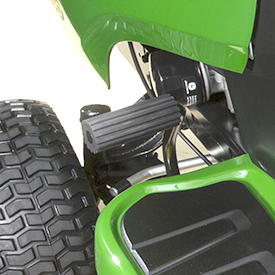 Brake/parking pedal
Brake/parking pedal
The parking brake control is conveniently located for easy access. It holds the brake pedal securely in the locked position.
Manual power take-off (PTO)
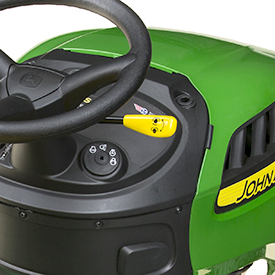 PTO engagement lever
PTO engagement lever
The mower deck is engaged with an easy-to-see and easy-to-use yellow lever on the dashboard. Its placement on the right side leaves a lot of room on the left, the entry side of the tractor, for the operator to get on and off the tractor.
Reverse implement option (RIO)
 RIO switch
RIO switch
Using RIO
CAUTION: Children or bystanders may be injured by rotating blades. Before traveling forward or rearward:
- Carefully check the area around the machine.
- Disengage the mower before backing up.
NOTE: Backing up while the mower is engaged is strongly discouraged. RIO should be used only when operating another attachment or when the operator deems it necessary to reposition the machine with the mower engaged.
- Stop forward travel.
- Look behind the machine to be sure there are no bystanders.
- Push and hold in the RIO switch while depressing the reverse pedal slightly for a hydrostatic transmission or moving the transmission shift lever to the rear slot (reverse) for a continuously variable transmission (CVT)/automatic transmission.
NOTE: If the engine and mower or other attachment stops while repositioning the machine, return the attachment engagement lever/switch to the off position. Start the engine and engage mower or other attachment. Begin again with step 2.
- Release the RIO switch and reposition the machine as the machine begins to move rearward.
- Resume forward travel. The mower or other attachment should continue operating.
- Repeat procedure to position the machine again.
Serviceability is convenient with easy-open hood
 One-piece hood is easy to open
One-piece hood is easy to open
 Service interval decal located under hood
Service interval decal located under hood
The one-piece hood opens easily to permit checking and servicing the engine:
- Important service points are located within easy reach.
- A service-interval decal is provided inside the tractor hood for convenience when servicing the tractor.
 John Deere Easy Change™ 30-second oil change system
John Deere Easy Change™ 30-second oil change system
 Seat tilted up for easy access to fuel-fill opening
Seat tilted up for easy access to fuel-fill opening
The John Deere Easy Change 30-second oil change system makes changing the engine oil easy, quick, and clean. Changing the oil is as easy as removing the old oil-filled filter and twisting on a new oil-filled filter. Oil does not need to be drained from the engine. The removed filter contains the captured contaminants and a portion of the engine oil.
The seat tilts up and out of the way to make adding fuel easy.
The 100 Series Tractors are covered by a 2-year/120-hour bumper-to-bumper warranty*:
- Premium features of 100 Series Tractors allow for this long warranty period.
*Term limited to years or hours used, whichever comes first, and varies by model. See the LIMITED WARRANTY FOR NEW JOHN DEERE TURF AND UTILITY EQUIPMENT at JohnDeere.com or JohnDeere.ca/TUWarranty for details.
Hood will not dent or rust and includes quality headlights for good visibility
 One-piece hood opens for service access
One-piece hood opens for service access
 Quality headlights for good visibility
Quality headlights for good visibility
The hood is made of molded-in color material:
- Reduces sound
- Will not rust or dent
- Openings on the side of the hood let in plenty of cooling air while keeping the sound level low.
- Two headlights provide good lighting for nighttime operation.
The MowerPlus™ app helps maintain the tractor and lawn
 MowerPlus app screen
MowerPlus app screen
 MowerPlus app maintenance screen
MowerPlus app maintenance screen
Keep a John Deere riding lawn mower running its best and know how it mows with the John Deere MowerPlus app. Simply scan the lawn tractor’s barcode to get custom information. The app helps determine the best time to mow, communicates expert pre-mow tips, offers maintenance reminders, and provides walk-through guides.
Look for the MowerPlus app on the iOS® or Android™ system app stores.
The app supports residential lawn equipment such as 100 Series, S240, X300, X500, X700, Z200 through Z600, and many similarly-sized older products. It does not presently support tractor models numbered 1000 and larger, such as 1025R.
NOTE: Some product image variation may exist.
MowerPlus hour meter connector also available (sold separately)
 MowerPlus hour meter connector packaging
MowerPlus hour meter connector packaging
The John Deere MowerPlus hour meter connector wirelessly links a 100 Series or S240 Lawn Tractor to the MowerPlus app on a mobile device. The hour meter connector transmits engine usage to the app, making it easy to track maintenance intervals:
- iOS version 10 or higher is compatible with the hour meter connector.
- Android versions are not compatible with the hour meter connector at this time.
iOS is a trademark of Cisco Technology, Inc. used under license by Apple Inc. Android is a trademark of Google LLC.
The Edge™ cutting system gives superior performance
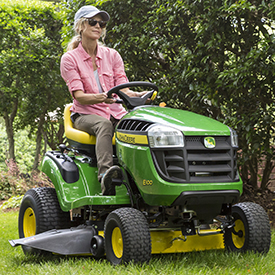 Mowing with 42-in. (107-cm) mower deck
Mowing with 42-in. (107-cm) mower deck
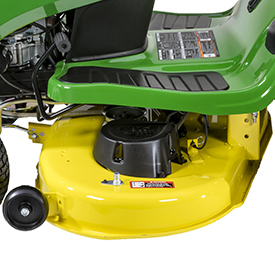 42-in. (107-cm) mower deck
42-in. (107-cm) mower deck
The Edge cutting system has been trademarked to emphasize the advantages of the John Deere mower deck designs. They give the mower superior convenience, performance, and reliability.
The 42-in. (107-cm) two-spindle, three-in-one mower is constructed of 13-gauge, 0.090-in. (2.3-mm) steel for long life:
- The mower deck has a rolled lip to provide greater strength and protection.
- The deep-deck mower design lifts grass for a clean, even cut.
- The smooth underside of the mower prevents grass buildup and evenly disperses grass clippings.
- The rolled outer edge of the deck provides extra strength and protection.
- Dual-stage E-coat and powder paint coatings provide extra protection from rust.
- No tools are required to go from mulching to side discharge to rear bagging.
- The blade-to-spindle design provides a unique mounting system for the mower blade that provides extra safety and convenience.
- A mulch cover is an optional attachment that can be installed without tools to allow mulching with the standard mower blades.
- A high-performance mulch plug is an optional attachment that includes a mulch plug and special mulching blades for excellent performance.
- A cut-and-throw, 6.5-bu (229-L) rear bagger is sold separately.
Mower wash port
 Mower wash port
Mower wash port
 Mower wash port with hose connector
Mower wash port with hose connector
A wash port is provided to make cleaning the underside of the mower deck easy:
-
A hose connector is included with mower deck.
StarLock™ blade design
 StarLock blade design
StarLock blade design
The StarLock blade design keeps the blade bolt at the correct torque for easy removal.
Optional blades for difficult mulching or bagging conditions are available.
Mower deck height adjustment
 Mower deck height adjustment lever
Mower deck height adjustment lever
A spring-assisted, low-effort, ergonomically designed lift lever simplifies setting and adjusting the mower cut height:
-
Increments of 0.25 in. (0.64 cm) allow the operator to fine-tune the cut height from 1 in. (2.5 cm) to 4 in. (10.2 cm).
-
The lift handle is shaped and located for easy use, and is out of the way of entering or exiting operators.
Two-year or 120-hour bumper-to-bumper warranty is standard
An exclusive 2-year or 120-hour (whichever comes first), single-source, bumper-to-bumper warranty* is standard for all John Deere 100 Series Tractors.
- The warranty is hassle free, with one company handling all of the paperwork.
- Premium features of 100 Series Tractors allow for this longer warranty period, with more coverage than comparable tractors.
*Term limited to years or hours used, whichever comes first, and varies by model. See the LIMITED WARRANTY FOR NEW JOHN DEERE TURF AND UTILITY EQUIPMENT at JohnDeere.com or JohnDeere.ca/TUWarranty for details.
Features
Powerful V-twin engine features full-pressure lubrication for dependability and long life
 20-hp (14.9-kW) engine
20-hp (14.9-kW) engine
A 20-hp (14.9-kW) V-twin engine has plenty of power and torque to handle tough mowing, mulching, and bagging conditions:
- V-twin cylinder design for greater torque, lower vibration, and improved sound quality
- Auto choke to allow operators to start the engine without needing the choke unless air temperatures are near or below freezing
- Spring-return feature to ensure the operator will not mistakenly leave the throttle lever in the choke position
- Electronic ignition for fast starts
- Cast-iron cylinder liners for longer engine life
- Overhead valves for excellent power and fuel economy
- Full-pressure lubrication and oil filter for cleaner oil, prolonging engine life and extending the time between oil changes
- More effective when operating the tractor on an incline
- John Deere Easy Change™ 30-second oil change system makes changing the engine oil easy, quick, and clean.
Fuel tank has gauge to show fuel level from the operator's seat
 Fuel tank gauge
Fuel tank gauge
 Convenient fuel-filler opening
Convenient fuel-filler opening
The fuel tank gauge shows how much fuel is in the tank and can be seen without leaving the operator's seat:
- Easy to check fuel level
- Convenient location
Fuel tank:
- The capacity is 2.4 U.S. gal. (9.1 L).
- The fuel-filler opening is conveniently located under the seat.
- Filling the tank without spilling is easy.
- A tethered fuel tank cap is more convenient.
- The sealed fuel cap helps keep vapors inside the tank.
- The tractor has a California Air Resources Board (CARB) certified engine for reduced air pollution.
John Deere Easy Change™ 30-second oil change system
 John Deere Easy Change 30-second oil change system
John Deere Easy Change 30-second oil change system
The John Deere Easy Change 30-second oil change system makes changing the engine oil easy, quick, and clean. Changing the oil is as easy as twisting on a new oil-filled filter. Oil does not need to be drained from the engine.
The John Deere Easy Change filter is an additional engine oil reservoir. Changing the filter removes the captured contaminants and replaces about 0.8 qt (0.76 L) of the engine oil.
The functionality does not stop with ease of use. The Easy Change oil system has several meaningful benefits over the traditional oil filter system of the 100 Series:
- A synthetic filter material is used for more predictable filtering and longer life.
- Filtering capacity is greater than with a standard oil filter.
- More filter surface area
- More oil flow capacity
- The system has 40 percent more oil volume.
- The oil and engine run cooler.
- The oil filter valve closes whenever the engine stops, so filtered particles are captured and cannot drain back into the engine.
- The risk of spilling during oil service is greatly reduced.
- Waste oil (and new oil production) is reduced by over 1,000,000 lb (453,592.4 kg) per tractor production year.
- This system is not a compromise to just make oil changes easier—these engines pass the same expectations and rigorous testing as always.
Partly due to these improvements, it is not necessary to remove and dispose of all the oil in the engine during service.
Everyone who uses the John Deere Easy Change system saves time and avoids the mess of a traditional oil change. In the past, many 100 Series Lawn Tractor owners rarely or never got around to changing their engine oil. With John Deere Easy Change, even owners who previously would not consider changing the oil themselves can easily do it. The Easy Change 30-second oil change system is a no-mess, no-fuss solution the competition cannot match.
Installation instructions are in the Operator’s Manual and in the John Deere Easy Change service part box.
Please recycle. Many local government recycling programs, authorized retailers, auto-service centers, and auto-parts stores will puncture and recycle used oil filters and oil.
Frame made of full-length welded steel for reliability
 Solid one-piece frame
Solid one-piece frame
 Solid one-piece frame
Solid one-piece frame
The solid one-piece frame is constructed of 12-gauge, 0.105-in. (2.66-mm) steel:
- Full-length, robotically-welded frame design has high-strength steel rails for added strength and long life.
- One-piece, steel fender deck is bolted to the frame.
Cast-iron front axle will not bend
 Front axle and wheel spindle
Front axle and wheel spindle
The front axle is constructed of solid cast iron that will not bend:
- Automotive-like steering system with sector and pinion steering gears and single drag link with a tie rod provides a very strong, low-effort, and tight-turning system.
- Three grease fittings, on both steering spindles and center pivot, allow for regular lubrication to help maintain easy steering and minimize wear.
- Large, 0.75-in. (1.9-cm) diameter wheel spindles provide excellent durability.
CargO Mount™ system makes installation of rear bagger and other attachments easy
 Rear CargO Mount points
Rear CargO Mount points
 Front CargO Mount points
Front CargO Mount points
 Rear bagger is mounted with CargO Mount points
Rear bagger is mounted with CargO Mount points
 Rear bagger is mounted with CargO Mount points
Rear bagger is mounted with CargO Mount points
The CargO Mount system is a combination of front- and rear-mounting points providing convenient and easy installation of the sun canopy, rear bagger, and other attachments.
Snow removal is a strength of lawn tractors
 Snow blower, weather enclosure, weights, and chains on a 100 Series Tractor
Snow blower, weather enclosure, weights, and chains on a 100 Series Tractor
 Front blade, weather enclosure, and chains on a 100 Series Tractor
Front blade, weather enclosure, and chains on a 100 Series Tractor
An advantage of lawn tractors is their ability to use equipment for snow removal. Lawn tractor owners can add a John Deere snow blower or front blade to make quick work of moving snow whenever the need arises. Weather enclosure and tire-chain attachments add comfort and performance.
Equipment available for snow removal includes:
- 44-in. (112-cm) Snow Blower
- 46-in. (117-cm) Front Blade
- Tire chains or TerraGrip traction belts
- Weather enclosure
- Weights
Hydrostatic transmission gives an infinite choice of ground speeds
 Two-pedal speed/direction controls
Two-pedal speed/direction controls
 Forward speed control pedal in use
Forward speed control pedal in use
A Kanzaki® Tuff Torq® hydrostatic transmission gives an infinite choice of speeds and makes changing the direction of travel easy. Side-by-side foot pedals control the speed and direction of travel:
- Automotive-type accelerator controls ensure easy operation.
- Operator can change direction without lifting foot off the platform.
- Large pedal surface gives superior operator comfort.
 Hydrostatic transmission
Hydrostatic transmission
Appropriate transmissions are used in each model, depending on rear tire size and tractor performance requirements, to ensure excellent performance and reliability:
- Tuff Torq TLT200A - E110, E120, E130
- Tuff Torq TLT200B - E140, E150, E160
- Tuff Torq K46AC - E170, E180
Standard cruise control (E120, E130, E150, E160, E170, and E180)
 Cruise control lever
Cruise control lever
An easy-to-use cruise control option maintains the tractor's speed for mowing larger areas:
- To engage, lift up on the cruise lever and hold it until the foot is removed from the forward pedal.
- To disengage, lightly press and then release the forward pedal.
- For emergency stops, cruise can be released by pushing on the brake pedal or pushing down on the cruise control lever.
NOTE: Cruise control is available on all models except the E100, E110, and E140.
Kanzaki and Tuff Torq are trademarks of Kanzaki Kokyukoki Manufacturing Company.
Operator station designed for comfortable operation
 Comfortable operator station, right side
Comfortable operator station, right side
 Comfortable operator station, left side
Comfortable operator station, left side
The operator station is designed for operator comfort and easy operation:
- Controls are positioned where they are easy to reach and use to control the tractor.
- The steering wheel is positioned and angled to give the operator plenty of room and steering comfort.
- The seat is tilted back at the optimum angle to provide the most comfortable operator position.
 Steering wheel and dash
Steering wheel and dash
 Wide footrest with debris-removal channels
Wide footrest with debris-removal channels
Controls are easy to see and use:
- Large, three-spoke steering wheel for greater operator comfort and control
- Ignition switch is on the dash for starting ease
Wide footrest areas with non-slip, anti-vibration floor mats are provided for operator comfort:
- Debris removing channels help keep the footrest area clean and dry
- The wide footrest makes it easier to step over the mower deck while entering or exiting the seat.
 Comfortable seat
Comfortable seat
 Easily-adjusted seat
Easily-adjusted seat
The operator seat has a 15-in. (38.1-cm) back height for good support. It is especially helpful when operating the tractor for extended periods of time. It can be easily adjusted forward or rearward while in the seat, with seat travel of 5.5 in. (14 cm) and 10 different positions.
 Seat springs give a smoother ride
Seat springs give a smoother ride
 Seat tilted forward (shown on E180 Tractor)
Seat tilted forward (shown on E180 Tractor)
Two long seat springs give plenty of seat travel to smooth out the ride, keeping the operator comfortable while operating the tractor.
The seat can be tilted forward for protection from the elements and to provide easy access to the fuel tank.
 Storage compartment with cover
Storage compartment with cover
 Beverage holder
Beverage holder
A storage compartment and beverage holder, located on the right-side fender, are conveniently located and easy to use.
NOTE: A storage compartment cover is standard on E120, E130, E150, E160, E170 and E180 Tractors and optional on the E110 and E140.
Instruments and controls are easy to find and convenient to use
 E120 Tractor mowing
E120 Tractor mowing
 Steering wheel and controls
Steering wheel and controls
Instruments and controls
The contoured dash has clean, attractive styling:
-
Controls are color coded and labeled for easy identification by the operator.
-
Controls are logically placed and easy to reach.
-
The hour meter makes it easy to tell when oil changes and other maintenance should be performed.
-
The service reminder feature will indicate that a general lubrication or mower/engine service interval has been reached.
-
When service is required, arrows will periodically flash for two hours.
-
Functional design of the controls provides good appearance and a comfortable feel.
Side-by-side transmission control pedals
 Hydro/automatic two-pedal speed/direction controls
Hydro/automatic two-pedal speed/direction controls
 Side-by-side foot pedals and cruise control lever
Side-by-side foot pedals and cruise control lever
Side-by-side foot pedals control the speed and direction of travel:
- Automotive-type accelerator controls ensure easy operation.
- Operator can change direction without lifting foot off the platform.
- Large pedal surface gives superior operator comfort.
Cruise control (E120, E130, E150, E160, E170, and E180)
 Cruise control lever
Cruise control lever
Cruise control is available on the E120, E130, E150, E160, E170, and E180:
- To engage, lift up on the cruise lever and hold until the foot is removed from the forward pedal.
- For emergency stop, the cruise control can be released by pushing on the brake pedal or the forward pedal.
Mower deck height adjustment
 Mower deck height-adjustment lever
Mower deck height-adjustment lever
A spring-assisted, low-effort lift lever simplifies setting and adjusting the mower cut height:
-
Increments of 0.25 in. (0.64 cm) allow for fine-tuning the cut height.
-
Cut height is adjustable from 1 in. (2.5 cm) to 4 in. (10.2 cm).
Parking brake control
 Parking brake lever
Parking brake lever
 Brake/parking pedal
Brake/parking pedal
The parking brake control is conveniently located for easy access. It holds the brake pedal securely in the locked position.
Manual power take-off (PTO)
 PTO engagement lever
PTO engagement lever
The mower deck is engaged with an easy-to-see and easy-to-use yellow lever on the dashboard. Its placement on the right side leaves a lot of room on the left, the entry side of the tractor, for the operator to get on and off the tractor.
Reverse implement option (RIO)
 RIO switch
RIO switch
Using RIO
CAUTION: Children or bystanders may be injured by rotating blades. Before traveling forward or rearward:
- Carefully check the area around the machine.
- Disengage the mower before backing up.
NOTE: Backing up while the mower is engaged is strongly discouraged. RIO should be used only when operating another attachment or when the operator deems it necessary to reposition the machine with the mower engaged.
- Stop forward travel.
- Look behind the machine to be sure there are no bystanders.
- Push and hold in the RIO switch while depressing the reverse pedal slightly for a hydrostatic transmission or moving the transmission shift lever to the rear slot (reverse) for a continuously variable transmission (CVT)/automatic transmission.
NOTE: If the engine and mower or other attachment stops while repositioning the machine, return the attachment engagement lever/switch to the off position. Start the engine and engage mower or other attachment. Begin again with step 2.
- Release the RIO switch and reposition the machine as the machine begins to move rearward.
- Resume forward travel. The mower or other attachment should continue operating.
- Repeat procedure to position the machine again.
Serviceability is convenient with easy-open hood
 One-piece hood is easy to open
One-piece hood is easy to open
 Service interval decal located under hood
Service interval decal located under hood
The one-piece hood opens easily to permit checking and servicing the engine:
- Important service points are located within easy reach.
- A service-interval decal is provided inside the tractor hood for convenience when servicing the tractor.
 John Deere Easy Change™ 30-second oil change system
John Deere Easy Change™ 30-second oil change system
 Seat tilted up for easy access to fuel-fill opening
Seat tilted up for easy access to fuel-fill opening
The John Deere Easy Change 30-second oil change system makes changing the engine oil easy, quick, and clean. Changing the oil is as easy as removing the old oil-filled filter and twisting on a new oil-filled filter. Oil does not need to be drained from the engine. The removed filter contains the captured contaminants and a portion of the engine oil.
The seat tilts up and out of the way to make adding fuel easy.
The 100 Series Tractors are covered by a 2-year/120-hour bumper-to-bumper warranty*:
- Premium features of 100 Series Tractors allow for this long warranty period.
*Term limited to years or hours used, whichever comes first, and varies by model. See the LIMITED WARRANTY FOR NEW JOHN DEERE TURF AND UTILITY EQUIPMENT at JohnDeere.com or JohnDeere.ca/TUWarranty for details.
Hood will not dent or rust and includes quality headlights for good visibility
 One-piece hood opens for service access
One-piece hood opens for service access
 Quality headlights for good visibility
Quality headlights for good visibility
The hood is made of molded-in color material:
- Reduces sound
- Will not rust or dent
- Openings on the side of the hood let in plenty of cooling air while keeping the sound level low.
- Two headlights provide good lighting for nighttime operation.
The MowerPlus™ app helps maintain the tractor and lawn
 MowerPlus app screen
MowerPlus app screen
 MowerPlus app maintenance screen
MowerPlus app maintenance screen
Keep a John Deere riding lawn mower running its best and know how it mows with the John Deere MowerPlus app. Simply scan the lawn tractor’s barcode to get custom information. The app helps determine the best time to mow, communicates expert pre-mow tips, offers maintenance reminders, and provides walk-through guides.
Look for the MowerPlus app on the iOS® or Android™ system app stores.
The app supports residential lawn equipment such as 100 Series, S240, X300, X500, X700, Z200 through Z600, and many similarly-sized older products. It does not presently support tractor models numbered 1000 and larger, such as 1025R.
NOTE: Some product image variation may exist.
MowerPlus hour meter connector also available (sold separately)
 MowerPlus hour meter connector packaging
MowerPlus hour meter connector packaging
The John Deere MowerPlus hour meter connector wirelessly links a 100 Series or S240 Lawn Tractor to the MowerPlus app on a mobile device. The hour meter connector transmits engine usage to the app, making it easy to track maintenance intervals:
- iOS version 10 or higher is compatible with the hour meter connector.
- Android versions are not compatible with the hour meter connector at this time.
iOS is a trademark of Cisco Technology, Inc. used under license by Apple Inc. Android is a trademark of Google LLC.
The Edge™ cutting system gives superior performance
 Mowing with 42-in. (107-cm) mower deck
Mowing with 42-in. (107-cm) mower deck
 42-in. (107-cm) mower deck
42-in. (107-cm) mower deck
The Edge cutting system has been trademarked to emphasize the advantages of the John Deere mower deck designs. They give the mower superior convenience, performance, and reliability.
The 42-in. (107-cm) two-spindle, three-in-one mower is constructed of 13-gauge, 0.090-in. (2.3-mm) steel for long life:
- The mower deck has a rolled lip to provide greater strength and protection.
- The deep-deck mower design lifts grass for a clean, even cut.
- The smooth underside of the mower prevents grass buildup and evenly disperses grass clippings.
- The rolled outer edge of the deck provides extra strength and protection.
- Dual-stage E-coat and powder paint coatings provide extra protection from rust.
- No tools are required to go from mulching to side discharge to rear bagging.
- The blade-to-spindle design provides a unique mounting system for the mower blade that provides extra safety and convenience.
- A mulch cover is an optional attachment that can be installed without tools to allow mulching with the standard mower blades.
- A high-performance mulch plug is an optional attachment that includes a mulch plug and special mulching blades for excellent performance.
- A cut-and-throw, 6.5-bu (229-L) rear bagger is sold separately.
Mower wash port
 Mower wash port
Mower wash port
 Mower wash port with hose connector
Mower wash port with hose connector
A wash port is provided to make cleaning the underside of the mower deck easy:
-
A hose connector is included with mower deck.
StarLock™ blade design
 StarLock blade design
StarLock blade design
The StarLock blade design keeps the blade bolt at the correct torque for easy removal.
Optional blades for difficult mulching or bagging conditions are available.
Mower deck height adjustment
 Mower deck height adjustment lever
Mower deck height adjustment lever
A spring-assisted, low-effort, ergonomically designed lift lever simplifies setting and adjusting the mower cut height:
-
Increments of 0.25 in. (0.64 cm) allow the operator to fine-tune the cut height from 1 in. (2.5 cm) to 4 in. (10.2 cm).
-
The lift handle is shaped and located for easy use, and is out of the way of entering or exiting operators.
Two-year or 120-hour bumper-to-bumper warranty is standard
An exclusive 2-year or 120-hour (whichever comes first), single-source, bumper-to-bumper warranty* is standard for all John Deere 100 Series Tractors.
- The warranty is hassle free, with one company handling all of the paperwork.
- Premium features of 100 Series Tractors allow for this longer warranty period, with more coverage than comparable tractors.
*Term limited to years or hours used, whichever comes first, and varies by model. See the LIMITED WARRANTY FOR NEW JOHN DEERE TURF AND UTILITY EQUIPMENT at JohnDeere.com or JohnDeere.ca/TUWarranty for details.
Features
Powerful engine features full-pressure lubrication for long life
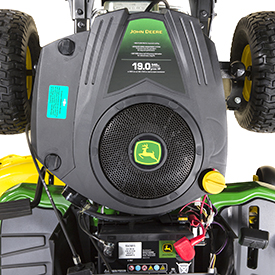 19-hp (14.2-kW) engine
19-hp (14.2-kW) engine
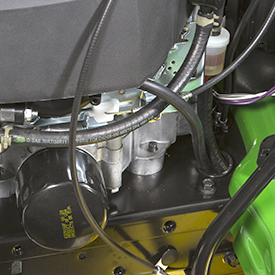 Engine oil filter and fuel filter
Engine oil filter and fuel filter
A 19-hp (14.2-kW) single-cylinder engine has plenty of power and torque to handle tough mulching, mowing, and bagging conditions:
- Electronic ignition for fast starts
- Spring-return feature to ensure the operator will not mistakenly leave the throttle lever in the choke position
- Cast-iron cylinder liner for long engine life
- Overhead valves for excellent power and fuel economy
- Anti-vibration system
- Full-pressure lubrication and oil filter for cleaner oil, prolonging engine life and extending the time between oil changes
- More effective when operating the tractor on an incline
- Large fuel filter for trouble-free operation
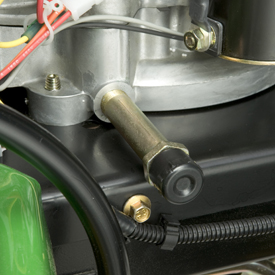 No-tools oil drain valve
No-tools oil drain valve
No-tools oil drain valve is easy to access when changing engine oil.
Fuel tank has gauge to show fuel level from the operator's seat
 Fuel tank gauge
Fuel tank gauge
 Convenient fuel-filler opening
Convenient fuel-filler opening
The fuel tank gauge shows how much fuel is in the tank and can be seen without leaving the operator's seat:
- Easy to check fuel level
- Convenient location
Fuel tank:
- The capacity is 2.4 U.S. gal. (9.1 L).
- The fuel-filler opening is conveniently located under the seat.
- Filling the tank without spilling is easy.
- A tethered fuel tank cap is more convenient.
- The sealed fuel cap helps keep vapors inside the tank.
- The tractor has a California Air Resources Board (CARB) certified engine for reduced air pollution.
Frame made of full-length welded steel for reliability
 Solid one-piece frame
Solid one-piece frame
 Solid one-piece frame
Solid one-piece frame
The solid one-piece frame is constructed of 12-gauge, 0.105-in. (2.66-mm) steel:
- Full-length, robotically-welded frame design has high-strength steel rails for added strength and long life.
- One-piece, steel fender deck is bolted to the frame.
Cast-iron front axle will not bend
 Front axle and wheel spindle
Front axle and wheel spindle
The front axle is constructed of solid cast iron that will not bend:
- Automotive-like steering system with sector and pinion steering gears and single drag link with a tie rod provides a very strong, low-effort, and tight-turning system.
- Three grease fittings, on both steering spindles and center pivot, allow for regular lubrication to help maintain easy steering and minimize wear.
- Large, 0.75-in. (1.9-cm) diameter wheel spindles provide excellent durability.
CargO Mount™ system makes installation of rear bagger and other attachments easy
 Rear CargO Mount points
Rear CargO Mount points
 Front CargO Mount points
Front CargO Mount points
 Rear bagger is mounted with CargO Mount points
Rear bagger is mounted with CargO Mount points
 Rear bagger is mounted with CargO Mount points
Rear bagger is mounted with CargO Mount points
The CargO Mount system is a combination of front- and rear-mounting points providing convenient and easy installation of the sun canopy, rear bagger, and other attachments.
Snow removal is a strength of lawn tractors
 Snow blower, weather enclosure, weights, and chains on a 100 Series Tractor
Snow blower, weather enclosure, weights, and chains on a 100 Series Tractor
 Front blade, weather enclosure, and chains on a 100 Series Tractor
Front blade, weather enclosure, and chains on a 100 Series Tractor
An advantage of lawn tractors is their ability to use equipment for snow removal. Lawn tractor owners can add a John Deere snow blower or front blade to make quick work of moving snow whenever the need arises. Weather enclosure and tire-chain attachments add comfort and performance.
Equipment available for snow removal includes:
- 44-in. (112-cm) Snow Blower
- 46-in. (117-cm) Front Blade
- Tire chains or TerraGrip traction belts
- Weather enclosure
- Weights
Hydrostatic transmission gives an infinite choice of ground speeds
 Two-pedal speed/direction controls
Two-pedal speed/direction controls
 Forward speed control pedal in use
Forward speed control pedal in use
A Kanzaki® Tuff Torq® hydrostatic transmission gives an infinite choice of speeds and makes changing the direction of travel easy. Side-by-side foot pedals control the speed and direction of travel:
- Automotive-type accelerator controls ensure easy operation.
- Operator can change direction without lifting foot off the platform.
- Large pedal surface gives superior operator comfort.
 Hydrostatic transmission
Hydrostatic transmission
Appropriate transmissions are used in each model, depending on rear tire size and tractor performance requirements, to ensure excellent performance and reliability:
- Tuff Torq TLT200A - E110, E120, E130
- Tuff Torq TLT200B - E140, E150, E160
- Tuff Torq K46AC - E170, E180
Standard cruise control (E120, E130, E150, E160, E170, and E180)
 Cruise control lever
Cruise control lever
An easy-to-use cruise control option maintains the tractor's speed for mowing larger areas:
- To engage, lift up on the cruise lever and hold it until the foot is removed from the forward pedal.
- To disengage, lightly press and then release the forward pedal.
- For emergency stops, cruise can be released by pushing on the brake pedal or pushing down on the cruise control lever.
NOTE: Cruise control is available on all models except the E100, E110, and E140.
Kanzaki and Tuff Torq are trademarks of Kanzaki Kokyukoki Manufacturing Company.
Operator station designed for operator comfort and convenience
 Comfortable operator station
Comfortable operator station
 Comfortable operator station, left side
Comfortable operator station, left side
The operator station is designed for operator comfort and easy operation:
- Controls are positioned where they are easy to reach and use to control the tractor.
- The steering wheel is positioned and angled to give the operator plenty of room and steering comfort.
- The seat is tilted back at the optimum angle to provide the most comfortable operator position.
 Steering wheel and dash
Steering wheel and dash
 Wide footrest with debris-removal channels
Wide footrest with debris-removal channels
Controls are easy to see and use:
- Large, three-spoke steering wheel for greater operator comfort and control
- Ignition switch is on the dash for starting ease
Wide footrest areas with non-slip, anti-vibration floor mats are provided for operator comfort:
- Optimum operator comfort
- Debris-removing channels help keep the footrest area clean and dry
 Comfortable seat
Comfortable seat
 Easily-adjusted seat
Easily-adjusted seat
The operator seat has an 11-in. (27.9-cm) back height for good support. It can be easily adjusted forward or rearward while in the seat, with seat travel of 5.5 in. (14 cm) and 10 different positions.
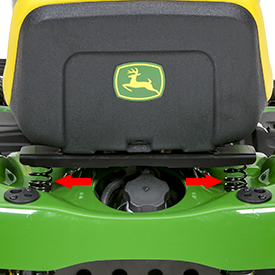 Seat springs give a smoother ride
Seat springs give a smoother ride
 Seat tilted forward (shown on E180 Tractor)
Seat tilted forward (shown on E180 Tractor)
Two long seat springs give plenty of seat travel to smooth out the ride, keeping the operator comfortable while operating the tractor.
The seat can be tilted forward for protection from the elements and to provide easy access to the fuel tank.
 Storage compartment (shown with optional cover)
Storage compartment (shown with optional cover)
 Beverage holder (optional storage compartment cover shown)
Beverage holder (optional storage compartment cover shown)
Storage compartment and beverage holder, located on the right side fender, are conveniently located and easy to use.
NOTE: A storage compartment cover is standard on E120, E130, E150, E160, E170, and E180 Tractors and optional on the E110 and E140.
Instruments and controls are easy to find and convenient to use
 E120 Tractor mowing
E120 Tractor mowing
 Steering wheel and controls
Steering wheel and controls
Instruments and controls
The contoured dash has clean, attractive styling:
-
Controls are color coded and labeled for easy identification by the operator.
-
Controls are logically placed and easy to reach.
-
The hour meter makes it easy to tell when oil changes and other maintenance should be performed.
-
The service reminder feature will indicate that a general lubrication or mower/engine service interval has been reached.
-
When service is required, arrows will periodically flash for two hours.
-
Functional design of the controls provides good appearance and a comfortable feel.
Side-by-side transmission control pedals
 Hydro/automatic two-pedal speed/direction controls
Hydro/automatic two-pedal speed/direction controls
 Side-by-side foot pedals and cruise control lever
Side-by-side foot pedals and cruise control lever
Side-by-side foot pedals control the speed and direction of travel:
- Automotive-type accelerator controls ensure easy operation.
- Operator can change direction without lifting foot off the platform.
- Large pedal surface gives superior operator comfort.
Cruise control (E120, E130, E150, E160, E170, and E180)
 Cruise control lever
Cruise control lever
Cruise control is available on the E120, E130, E150, E160, E170, and E180:
- To engage, lift up on the cruise lever and hold until the foot is removed from the forward pedal.
- For emergency stop, the cruise control can be released by pushing on the brake pedal or the forward pedal.
Mower deck height adjustment
 Mower deck height-adjustment lever
Mower deck height-adjustment lever
A spring-assisted, low-effort lift lever simplifies setting and adjusting the mower cut height:
-
Increments of 0.25 in. (0.64 cm) allow for fine-tuning the cut height.
-
Cut height is adjustable from 1 in. (2.5 cm) to 4 in. (10.2 cm).
Parking brake control
 Parking brake lever
Parking brake lever
 Brake/parking pedal
Brake/parking pedal
The parking brake control is conveniently located for easy access. It holds the brake pedal securely in the locked position.
Manual power take-off (PTO)
 PTO engagement lever
PTO engagement lever
The mower deck is engaged with an easy-to-see and easy-to-use yellow lever on the dashboard. Its placement on the right side leaves a lot of room on the left, the entry side of the tractor, for the operator to get on and off the tractor.
Reverse implement option (RIO)
 RIO switch
RIO switch
Using RIO
CAUTION: Children or bystanders may be injured by rotating blades. Before traveling forward or rearward:
- Carefully check the area around the machine.
- Disengage the mower before backing up.
NOTE: Backing up while the mower is engaged is strongly discouraged. RIO should be used only when operating another attachment or when the operator deems it necessary to reposition the machine with the mower engaged.
- Stop forward travel.
- Look behind the machine to be sure there are no bystanders.
- Push and hold in the RIO switch while depressing the reverse pedal slightly for a hydrostatic transmission or moving the transmission shift lever to the rear slot (reverse) for a continuously variable transmission (CVT)/automatic transmission.
NOTE: If the engine and mower or other attachment stops while repositioning the machine, return the attachment engagement lever/switch to the off position. Start the engine and engage mower or other attachment. Begin again with step 2.
- Release the RIO switch and reposition the machine as the machine begins to move rearward.
- Resume forward travel. The mower or other attachment should continue operating.
- Repeat procedure to position the machine again.
Serviceability is convenient with an easy-open hood
 One-piece hood is easy to open
One-piece hood is easy to open
 Service interval decal located under hood
Service interval decal located under hood
The one-piece hood opens easily to permit checking and servicing the engine:
- Important service points are located within easy reach.
- A service interval decal is provided inside the tractor hood for convenience when servicing the tractor.
- Hour meter includes a service reminder feature that flashes for two hours when a lubrication or mower/engine service interval has been reached.
 Easy-to-service engine fuel and oil filters
Easy-to-service engine fuel and oil filters
 Seat tilted up for easy access to fuel-fill opening
Seat tilted up for easy access to fuel-fill opening
The engine fuel and oil filters, the oil check/fill tube, and the oil drain tube are exposed for serviceability when the hood is opened.
The seat tilts up and out of the way to make adding fuel easy.
The 100 Series Tractors are covered by a 2-year/120-hour bumper-to-bumper warranty*:
- Premium features of 100 Series Tractors allow for this long warranty period.
*Term limited to years or hours used, whichever comes first, and varies by model. See the LIMITED WARRANTY FOR NEW JOHN DEERE TURF AND UTILITY EQUIPMENT at JohnDeere.com or JohnDeere.ca/TUWarranty for details.
Hood will not dent or rust and includes quality headlights for good visibility
 One-piece hood opens for service access
One-piece hood opens for service access
 Quality headlights for good visibility
Quality headlights for good visibility
The hood is made of molded-in color material:
- Reduces sound
- Will not rust or dent
- Openings on the side of the hood let in plenty of cooling air while keeping the sound level low.
- Two headlights provide good lighting for nighttime operation.
The MowerPlus™ app helps maintain the tractor and lawn
 MowerPlus app screen
MowerPlus app screen
 MowerPlus app maintenance screen
MowerPlus app maintenance screen
Keep a John Deere riding lawn mower running its best and know how it mows with the John Deere MowerPlus app. Simply scan the lawn tractor’s barcode to get custom information. The app helps determine the best time to mow, communicates expert pre-mow tips, offers maintenance reminders, and provides walk-through guides.
Look for the MowerPlus app on the iOS® or Android™ system app stores.
The app supports residential lawn equipment such as 100 Series, S240, X300, X500, X700, Z200 through Z600, and many similarly-sized older products. It does not presently support tractor models numbered 1000 and larger, such as 1025R.
NOTE: Some product image variation may exist.
MowerPlus hour meter connector also available (sold separately)
 MowerPlus hour meter connector packaging
MowerPlus hour meter connector packaging
The John Deere MowerPlus hour meter connector wirelessly links a 100 Series or S240 Lawn Tractor to the MowerPlus app on a mobile device. The hour meter connector transmits engine usage to the app, making it easy to track maintenance intervals:
- iOS version 10 or higher is compatible with the hour meter connector.
- Android versions are not compatible with the hour meter connector at this time.
iOS is a trademark of Cisco Technology, Inc. used under license by Apple Inc. Android is a trademark of Google LLC.
The Edge™ cutting system gives superior performance
 Mowing with 42-in. (107-cm) mower deck
Mowing with 42-in. (107-cm) mower deck
 42-in. (107-cm) mower deck
42-in. (107-cm) mower deck
The Edge cutting system has been trademarked to emphasize the advantages of the John Deere mower deck designs. They give the mower superior convenience, performance, and reliability.
The 42-in. (107-cm) two-spindle, three-in-one mower is constructed of 13-gauge, 0.090-in. (2.3-mm) steel for long life:
- The mower deck has a rolled lip to provide greater strength and protection.
- The deep-deck mower design lifts grass for a clean, even cut.
- The smooth underside of the mower prevents grass buildup and evenly disperses grass clippings.
- The rolled outer edge of the deck provides extra strength and protection.
- Dual-stage E-coat and powder paint coatings provide extra protection from rust.
- No tools are required to go from mulching to side discharge to rear bagging.
- The blade-to-spindle design provides a unique mounting system for the mower blade that provides extra safety and convenience.
- A mulch cover is an optional attachment that can be installed without tools to allow mulching with the standard mower blades.
- A high-performance mulch plug is an optional attachment that includes a mulch plug and special mulching blades for excellent performance.
- A cut-and-throw, 6.5-bu (229-L) rear bagger is sold separately.
Mower wash port
 Mower wash port
Mower wash port
 Mower wash port with hose connector
Mower wash port with hose connector
A wash port is provided to make cleaning the underside of the mower deck easy:
-
A hose connector is included with mower deck.
StarLock™ blade design
 StarLock blade design
StarLock blade design
The StarLock blade design keeps the blade bolt at the correct torque for easy removal.
Optional blades for difficult mulching or bagging conditions are available.
Mower deck height adjustment
 Mower deck height adjustment lever
Mower deck height adjustment lever
A spring-assisted, low-effort, ergonomically designed lift lever simplifies setting and adjusting the mower cut height:
-
Increments of 0.25 in. (0.64 cm) allow the operator to fine-tune the cut height from 1 in. (2.5 cm) to 4 in. (10.2 cm).
-
The lift handle is shaped and located for easy use, and is out of the way of entering or exiting operators.
Two-year or 120-hour bumper-to-bumper warranty is standard
An exclusive 2-year or 120-hour (whichever comes first), single-source, bumper-to-bumper warranty* is standard for all John Deere 100 Series Tractors.
- The warranty is hassle free, with one company handling all of the paperwork.
- Premium features of 100 Series Tractors allow for this longer warranty period, with more coverage than comparable tractors.
*Term limited to years or hours used, whichever comes first, and varies by model. See the LIMITED WARRANTY FOR NEW JOHN DEERE TURF AND UTILITY EQUIPMENT at JohnDeere.com or JohnDeere.ca/TUWarranty for details.
Features
Powerful engine features full-pressure lubrication for long life
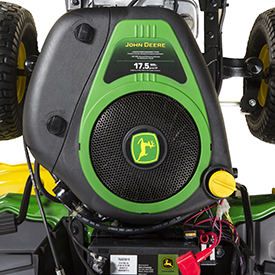 17.5-hp (13.0-kW) engine
17.5-hp (13.0-kW) engine
 Engine oil filter and fuel filter
Engine oil filter and fuel filter
A 17.5-hp (13.0-kW), single-cylinder engine has plenty of power and torque to handle tough mowing, mulching, and bagging conditions:
- Electronic ignition for fast starts
- Spring-return feature to ensure the operator will not mistakenly leave the throttle lever in the choke position
- Cast-iron cylinder liner for long engine life
- Overhead valves for excellent power and fuel economy
- Anti-vibration system
- Full-pressure lubrication and oil filter for cleaner oil, prolonging engine life, and extending the time between oil changes
- More effective when operating the tractor on an incline
- Large fuel filter for trouble-free operation
 No-tools oil drain valve
No-tools oil drain valve
The no-tools oil drain valve is easy to access when changing engine oil.
Fuel tank has gauge to show fuel level from the operator's seat
 Fuel tank gauge
Fuel tank gauge
 Convenient fuel-filler opening
Convenient fuel-filler opening
The fuel tank gauge shows how much fuel is in the tank and can be seen without leaving the operator's seat:
- Easy to check fuel level
- Convenient location
Fuel tank:
- The capacity is 2.4 U.S. gal. (9.1 L).
- The fuel-filler opening is conveniently located under the seat.
- Filling the tank without spilling is easy.
- A tethered fuel tank cap is more convenient.
- The sealed fuel cap helps keep vapors inside the tank.
- The tractor has a California Air Resources Board (CARB) certified engine for reduced air pollution.
Frame made of full-length welded steel for reliability
 Solid one-piece frame
Solid one-piece frame
 Solid one-piece frame
Solid one-piece frame
The solid one-piece frame is constructed of 12-gauge, 0.105-in. (2.66-mm) steel:
- Full-length, robotically-welded frame design has high-strength steel rails for added strength and long life.
- One-piece, steel fender deck is bolted to the frame.
Cast-iron front axle will not bend
 Front axle and wheel spindle
Front axle and wheel spindle
The front axle is constructed of solid cast iron that will not bend:
- Automotive-like steering system with sector and pinion steering gears and single drag link with a tie rod provides a very strong, low-effort, and tight-turning system.
- Three grease fittings, on both steering spindles and center pivot, allow for regular lubrication to help maintain easy steering and minimize wear.
- Large, 0.75-in. (1.9-cm) diameter wheel spindles provide excellent durability.
CargO Mount™ system makes installation of rear bagger and other attachments easy
 Rear CargO Mount points
Rear CargO Mount points
 Front CargO Mount points
Front CargO Mount points
 Rear bagger is mounted with CargO Mount points
Rear bagger is mounted with CargO Mount points
 Rear bagger is mounted with CargO Mount points
Rear bagger is mounted with CargO Mount points
The CargO Mount system is a combination of front- and rear-mounting points providing convenient and easy installation of the sun canopy, rear bagger, and other attachments.
Snow removal is a strength of lawn tractors
 Snow blower, weather enclosure, weights, and chains on a 100 Series Tractor
Snow blower, weather enclosure, weights, and chains on a 100 Series Tractor
 Front blade, weather enclosure, and chains on a 100 Series Tractor
Front blade, weather enclosure, and chains on a 100 Series Tractor
An advantage of lawn tractors is their ability to use equipment for snow removal. Lawn tractor owners can add a John Deere snow blower or front blade to make quick work of moving snow whenever the need arises. Weather enclosure and tire-chain attachments add comfort and performance.
Equipment available for snow removal includes:
- 44-in. (112-cm) Snow Blower
- 46-in. (117-cm) Front Blade
- Tire chains or TerraGrip traction belts
- Weather enclosure
- Weights
Automatic transmission makes it easy to choose the exact travel speed for each operating condition
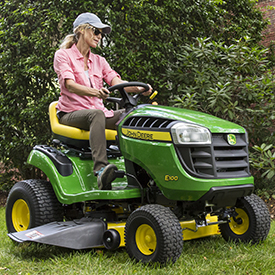 E100 Tractor
E100 Tractor
The automatic transmission allows the operator to easily choose the desired forward or reverse travel speed by simply depressing a single foot pedal; this is similar to the way the driver of an automobile with automatic transmission changes speed when depressing the accelerator.
Whether a slow speed for trimming or faster speed for open-area mowing is desired, the operator can easily adjust by how far the foot pedal is depressed.
 Brake pedal
Brake pedal
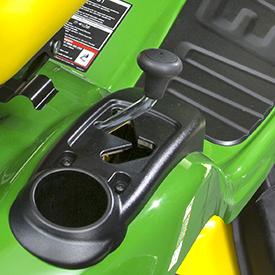 Automatic transmission forward/reverse shift lever
Automatic transmission forward/reverse shift lever
With the brake pedal depressed and the forward/reverse lever in the center position, the engine can be started. Once the engine is started, it is not necessary to use the brake pedal when selecting forward or reverse. Simply move the forward/reverse lever to select travel direction, and then press the automatic foot pedal to choose from an infinite number of travel speeds.
 Speed control pedal
Speed control pedal
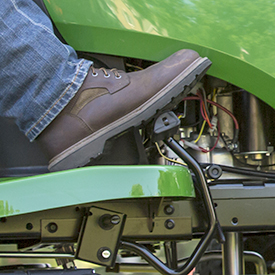 Operator foot depressing speed control pedal
Operator foot depressing speed control pedal
With the automatic speed control pedal, the operator can choose from an infinite number of speeds forward or reverse:
- Forward: 0 to 5.5 mph (0 to 8.9 km/h)
- Reverse: 0 to 3.2 mph (0 to 5.1 km/h)
Operator station designed for comfortable operation
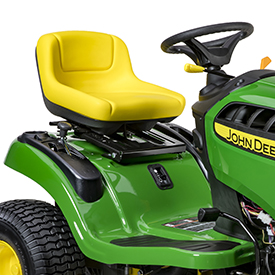 Comfortable operator station, right side
Comfortable operator station, right side
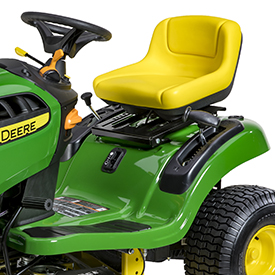 Comfortable operator station, left side
Comfortable operator station, left side
The operator station is designed for operator comfort and easy operation:
- Controls are positioned where they are easy to reach and easy to use to control the tractor.
- Steering wheel is positioned and angled to give the operator plenty of room and steering comfort.
- Seat is tilted back at the optimum angle to provide the most comfortable operator position.
 Steering wheel and dash
Steering wheel and dash
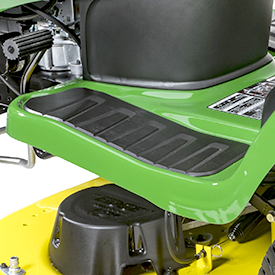 Wide footrest with debris channels
Wide footrest with debris channels
Controls are easy to see and use:
- Large, three-spoke steering wheel for greater operator comfort and control
- Ignition switch is on the dash for starting ease
Wide footrest areas with non-slip, anti-vibration floor mats are provided for operator comfort:
- Footrest area is designed for optimum operator comfort
- Debris-removing channels help keep the footrest area clean and dry
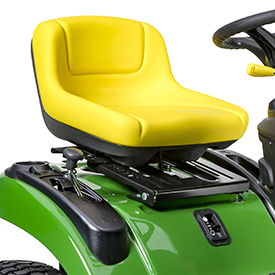 Comfortable seat
Comfortable seat
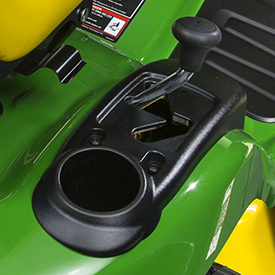 Easily-adjusted seat and beverage holder
Easily-adjusted seat and beverage holder
The operator seat has an 11-in. (27.9-cm) back height for good support. It can be easily adjusted forward or rearward while the operator is in the seat, with seat travel of 5.5 in. (14 cm) and 10 different positions.
A beverage holder is located on the right-side fender for operator convenience.
 Seat springs give a smoother ride
Seat springs give a smoother ride
 Seat tilted forward (shown on E180 Tractor)
Seat tilted forward (shown on E180 Tractor)
Two long seat springs give plenty of seat travel to smooth out the ride, keeping the operator comfortable while operating the tractor.
Seat can be tilted forward for protection from the elements and to provide easy access to the fuel tank.
Instruments and controls are easy to find and convenient to use
 E100 Tractor mowing
E100 Tractor mowing
 Steering wheel and controls
Steering wheel and controls
Instruments and controls
The contoured dash has clean, attractive styling:
-
Controls are color coded and labeled for easy identification by the operator.
-
Controls are logically placed and easy to reach.
-
The hour meter makes it easy to tell when oil changes and other maintenance should be performed.
-
The service reminder feature will indicate that a general lubrication or mower/engine service interval has been reached.
-
When service is required, arrows will periodically flash for two hours.
-
Functional design of the controls provides good appearance and a comfortable feel.
Mower deck height adjustment
 Mower deck height adjustment lever
Mower deck height adjustment lever
A spring-assisted, low-effort lift lever simplifies setting and adjusting the mower cut height:
-
Increments of 0.25-in. (0.64-cm) allow for fine-tuning the cut height.
-
Cut height is adjustable from 1-in. (2.5 cm) to 4 in. (10.2 cm).
Parking brake control
 Parking brake lever
Parking brake lever
 Brake/parking brake pedal
Brake/parking brake pedal
The parking brake control is conveniently located on the tractor pedestal for easy access. It holds the brake pedal securely in the locked position.
Manual power take-off (PTO)
 PTO engagement lever
PTO engagement lever
The mower deck is engaged with the easy-to-see and easy-to-use yellow lever above the dashboard. Its placement on the right side leaves a lot of room on the left, the entry side of the tractor, for the operator to get on and off the tractor.
Reverse implement option (RIO)
 RIO switch
RIO switch
Using RIO
CAUTION: Children or bystanders may be injured by rotating blades. Before traveling forward or rearward:
- Carefully check the area around the machine.
- Disengage the mower before backing up.
NOTE: Backing up while the mower is engaged is strongly discouraged. RIO should be used only when operating another attachment or when the operator deems it necessary to reposition the machine with the mower engaged.
- Stop forward travel.
- Look behind the machine to be sure there are no bystanders.
- Push and hold in the RIO switch while depressing the reverse pedal slightly for a hydrostatic transmission or moving the transmission shift lever to the rear slot (reverse) for a continuously variable transmission (CVT)/automatic transmission.
NOTE: If the engine and mower or other attachment stops while repositioning the machine, return the attachment engagement lever/switch to the off position. Start the engine and engage mower or other attachment. Begin again with step 2.
- Release the RIO switch and reposition the machine as the machine begins to move rearward.
- Resume forward travel. The mower or other attachment should continue operating.
- Repeat procedure to position the machine again.
Serviceability is convenient with an easy-open hood
 One-piece hood is easy to open
One-piece hood is easy to open
 Service interval decal located under hood
Service interval decal located under hood
The one-piece hood opens easily to permit checking and servicing the engine:
- Important service points are located within easy reach.
- A service interval decal is provided inside the tractor hood for convenience when servicing the tractor.
- Hour meter includes a service reminder feature that flashes for two hours when a lubrication or mower/engine service interval has been reached.
 Easy-to-service engine fuel and oil filters
Easy-to-service engine fuel and oil filters
 Seat tilted up for easy access to fuel-fill opening
Seat tilted up for easy access to fuel-fill opening
The engine fuel and oil filters, the oil check/fill tube, and the oil drain tube are exposed for serviceability when the hood is opened.
The seat tilts up and out of the way to make adding fuel easy.
The 100 Series Tractors are covered by a 2-year/120-hour bumper-to-bumper warranty*:
- Premium features of 100 Series Tractors allow for this long warranty period.
*Term limited to years or hours used, whichever comes first, and varies by model. See the LIMITED WARRANTY FOR NEW JOHN DEERE TURF AND UTILITY EQUIPMENT at JohnDeere.com or JohnDeere.ca/TUWarranty for details.
Hood will not dent or rust and includes quality headlights for good visibility
 One-piece hood opens for service access
One-piece hood opens for service access
 Quality headlights for good visibility
Quality headlights for good visibility
The hood is made of molded-in color material:
- Reduces sound
- Will not rust or dent
- Openings on the side of the hood let in plenty of cooling air while keeping the sound level low.
- Two headlights provide good lighting for nighttime operation.
The MowerPlus™ app helps maintain the tractor and lawn
 MowerPlus app screen
MowerPlus app screen
 MowerPlus app maintenance screen
MowerPlus app maintenance screen
Keep a John Deere riding lawn mower running its best and know how it mows with the John Deere MowerPlus app. Simply scan the lawn tractor’s barcode to get custom information. The app helps determine the best time to mow, communicates expert pre-mow tips, offers maintenance reminders, and provides walk-through guides.
Look for the MowerPlus app on the iOS® or Android™ system app stores.
The app supports residential lawn equipment such as 100 Series, S240, X300, X500, X700, Z200 through Z600, and many similarly-sized older products. It does not presently support tractor models numbered 1000 and larger, such as 1025R.
NOTE: Some product image variation may exist.
MowerPlus hour meter connector also available (sold separately)
 MowerPlus hour meter connector packaging
MowerPlus hour meter connector packaging
The John Deere MowerPlus hour meter connector wirelessly links a 100 Series or S240 Lawn Tractor to the MowerPlus app on a mobile device. The hour meter connector transmits engine usage to the app, making it easy to track maintenance intervals:
- iOS version 10 or higher is compatible with the hour meter connector.
- Android versions are not compatible with the hour meter connector at this time.
iOS is a trademark of Cisco Technology, Inc. used under license by Apple Inc. Android is a trademark of Google LLC.
The Edge™ cutting system gives superior performance
 Mowing with 42-in. (107-cm) mower deck
Mowing with 42-in. (107-cm) mower deck
 42-in. (107-cm) mower deck
42-in. (107-cm) mower deck
The Edge cutting system has been trademarked to emphasize the advantages of the John Deere mower deck designs. They give the mower superior convenience, performance, and reliability.
The 42-in. (107-cm) two-spindle, three-in-one mower is constructed of 13-gauge, 0.090-in. (2.3-mm) steel for long life:
- The mower deck has a rolled lip to provide greater strength and protection.
- The deep-deck mower design lifts grass for a clean, even cut.
- The smooth underside of the mower prevents grass buildup and evenly disperses grass clippings.
- The rolled outer edge of the deck provides extra strength and protection.
- Dual-stage E-coat and powder paint coatings provide extra protection from rust.
- No tools are required to go from mulching to side discharge to rear bagging.
- The blade-to-spindle design provides a unique mounting system for the mower blade that provides extra safety and convenience.
- A mulch cover is an optional attachment that can be installed without tools to allow mulching with the standard mower blades.
- A high-performance mulch plug is an optional attachment that includes a mulch plug and special mulching blades for excellent performance.
- A cut-and-throw, 6.5-bu (229-L) rear bagger is sold separately.
Mower wash port
 Mower wash port
Mower wash port
 Mower wash port with hose connector
Mower wash port with hose connector
A wash port is provided to make cleaning the underside of the mower deck easy:
-
A hose connector is included with mower deck.
StarLock™ blade design
 StarLock blade design
StarLock blade design
The StarLock blade design keeps the blade bolt at the correct torque for easy removal.
Optional blades for difficult mulching or bagging conditions are available.
Mower deck height adjustment
 Mower deck height adjustment lever
Mower deck height adjustment lever
A spring-assisted, low-effort, ergonomically designed lift lever simplifies setting and adjusting the mower cut height:
-
Increments of 0.25 in. (0.64 cm) allow the operator to fine-tune the cut height from 1 in. (2.5 cm) to 4 in. (10.2 cm).
-
The lift handle is shaped and located for easy use, and is out of the way of entering or exiting operators.
Two-year or 120-hour bumper-to-bumper warranty is standard
An exclusive 2-year or 120-hour (whichever comes first), single-source, bumper-to-bumper warranty* is standard for all John Deere 100 Series Tractors.
- The warranty is hassle free, with one company handling all of the paperwork.
- Premium features of 100 Series Tractors allow for this longer warranty period, with more coverage than comparable tractors.
*Term limited to years or hours used, whichever comes first, and varies by model. See the LIMITED WARRANTY FOR NEW JOHN DEERE TURF AND UTILITY EQUIPMENT at JohnDeere.com or JohnDeere.ca/TUWarranty for details.
Features
Power steering for excellent handling characteristics and low steering effort
The Gator™ RSX High-Performance Series Utility Vehicles are equipped with rack and pinion steering with power steering and a dual A-arm front suspension. These automotive-type systems exhibit excellent handling characteristics, as well as responsive steering and low steering effort.
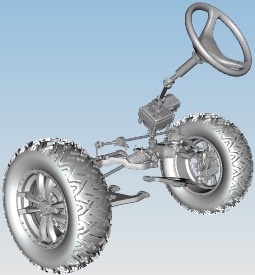 Automotive-type rack and pinion steering with power steering
Automotive-type rack and pinion steering with power steering
Automotive-type rack and pinion steering features include:
- Electronic power-steering assist system (EPAS). Features of EPAS include:
- Anti-kickback feature reduces the amount of steering unwinding when traversing difficult terrain.
- The system is speed sensing and adjusts steering effort as the speed of the vehicle changes.
- As speed increases there is less steering assist for improved road feel.
- As speed decreases steering assist increases to give lower steering efforts for improved maneuverability.
- A warning/functional light on the instrument panel provides self-diagnostics and a warning light in the situation of no assist.
- Torque sensor measures steering wheel input so the on-board computer can provide the appropriate output for various driving situations.
- Steel ball-bearings secure the steering shaft and delivers smooth, responsive operation
- Tight turn radius of 3.7 m (12.3 ft) for excellent maneuverability
- Completely sealed rack-and-pinion for long life
- Low steering ratio (lock-to-lock steering wheel rotations) provides more responsive steering and less operator input
- Shaft U-joints are phased for a smooth, uninterrupted motion of the steering wheel
- Ackerman steering design provides more responsive steering, decreases tire wear when used on hard surfaces and is turf friendly (see description below)
- Minimal bump steer eliminates unintended vehicle direction changes when traversing terrain and permits less feedback to the steering wheel (see description below)
The tire scrubbing, which also creates unwanted heat and wear in the tire, can be eliminated by turning the inside wheel at a greater angle than the outside one (Ackerman steering).
NOTE: Some competitors use parallel steering instead of Ackerman steering.
Bump steering defines the change in the forward steering angle (thus wheel position) as the suspension travels through its full motion. A large amount of angular change (5 degrees to 7 degrees) will alter the vehicle's direction and excessively move the steering wheel.
Winch-ready chassis
Having the utility vehicles come pre-wired for a winch from the factory greatly reduces the winch install time. Two of the RSX860M chassis come from the factory prewired for a winch: all power steering models and the winch-ready chassis.
Components included in the winch-ready chassis factory installed:
- Winch wiring harness
- Negative winch battery cable
- Winch disconnect wiring harness
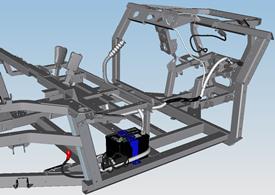 Chassis with prewiring for winch
Chassis with prewiring for winch
A dealer-installed version of the WARN® ProVantage 1587.6-kg (3500-lb) winch for these chassis is available through Parts. Please reference the Price Pages/Configurator for the attachment number.
WARN is a trademark of WARN Industries, Inc.
Delivers exhilarating acceleration and provides a top speed of 97 km/h (60 mph)
Engine, fuel, exhaust, and intake
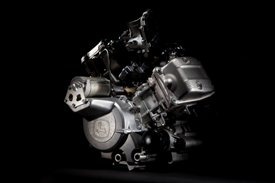 839-cc (51.2-cu in.) gasoline engine
839-cc (51.2-cu in.) gasoline engine
The RSX860 is powered by an 839-cc (51.2-cu in.), V-twin, four-cycle motorcycle gasoline engine. It produces 46.2 kW (62 hp*) and 80.6 Nm (59.5 lb-ft) of torque. The advanced electronic controls and fuel-injection systems deliver superb starting, idling, and throttle response during operation.
The engine offers the following performance and reliability features:
- Delivers exhilarating acceleration for excellent performance
- 97-km/h (60-mph) top speed
- Mounted transversely under the seats for a low center of gravity and more equal weight distribution between the front and rear axles
- Closed-loop electronic fuel injection for superb performance, instant throttle response, consistent performance at high altitude, and hassle-free cold-weather starting (tested to -20°F, or -29°C)
- Dual oxygen sensors provide a more accurate air-to-fuel ratio balance between cylinders, increasing ability to start and overall engine performance
- Engine control unit (ECU) cutout to protect critical drive components when the wheel speed far exceeds the vehicle speed
- Liquid cooled for quieter operation and optimal performance
- Four-valve-per-cylinder design provides greater efficiency and fuel economy
- Dry sump oiling system
- More efficiently lubricates the engine resulting in more available horsepower over a conventional wet sump design
- Oil tank is more easily accessible for checking and filling the oil
- Allows for the engine to be mounted low in the vehicle to lower the center of gravity
- Oil cooler in front of the radiator to help keep engine oil at lower operating temperatures
- Full-pressure lubrication system
- Spin-on oil filter with drain bracket and oil drain valve enable easy servicing
- High-flow air filter
- Utilizes nano-fiber technology to increase the efficiency of the filtration without sacrificing horsepower
- See-through coolant recovery tank permits the operator to check the coolant level without having to remove the radiator cap
- Sealed radiator compartment keeps trash and debris on the outside of the grille
- 450 W maximum magneto charging system
- Auto-start electronic ignition system optimizes ECU inputs for easy starting
- Electronic ignition is continuously variable for optimum engine power and provides fast, reliable starts
- Exhaust system design
- Large-diameter header pipes optimized for maximum horsepower output collect in high-volume muffler
- Full stainless steel for longevity under severe loading and heat
- Additional heat wrap ensures heat dissipation through the tail pipe
- Spark-arresting muffler is United Stated Forest Service (USFS) approved
- Large 28-L (7.4-gal.) fuel tank
- An engine isolation system dramatically reduces engine vibration and noise. Engine vibration will be reduced by 67-83 percent on the floor, and the noise will be reduced by 2-4 dB(A)
*Engine horsepower is provided by the engine manufacturer to be used for comparison purposes only. Actual operating horsepower will be less. Refer to the engine manufacturer’s website for additional information.
Large, extra-durable, one-piece cargo box ensures hard-driving performance and longevity
The cargo box consists of a high-density polyethylene copolymer composite material that eliminates rust, dents, and reduces noise. This large, one-piece design has rounded inside corners to ensure material removal when tilted. The composite box is highly ribbed and supported with a welded steel-ladder structure to ensure hard-driving performance and longevity. The three highly styled exterior pieces are made of thermoplastic polyolefin (TPO) for extra durability.
Cargo box tailgate
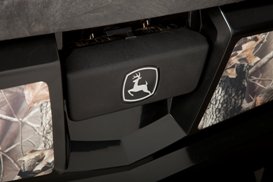 Tailgate handle
Tailgate handle
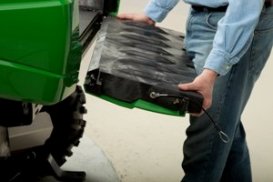 Removable tailgate
Removable tailgate
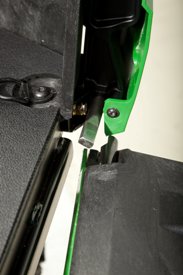 Tailgate pivot
Tailgate pivot
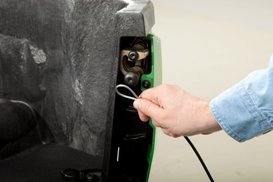 Removable lanyards
Removable lanyards
The tailgate can be opened or removed for easier cleanout and to carry longer items. It features truck-like performance and can be operated with one hand.
The tailgate’s pivot point is made of hardened steel for durability and designed for tool-less removal. The standard lanyards can also be disconnected without tools to remove the tailgate for convenient loading and unloading tasks.
Cargo box tilt and removal
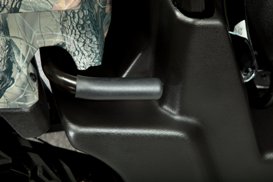 Integrated handle for manual cargo-box tilt
Integrated handle for manual cargo-box tilt
The cargo box ease of use is critical to performing tasks quickly and efficiently. Starting with the truck-style tailgate, the removal of content in this cargo box is much easier. The manual release functions as the lift lever as well, done in a smooth, one step motion. It can even be tilted from both sides of the vehicle. To reduce the overall effort of lift, the pivot point of the cargo box is closer to the center. The combination of easy-to-use attributes makes this cargo box best in class.
With the removal of two bolts, the cargo box can easily be detached from the vehicle frame for ease of servicing.
Integrated tie-down points
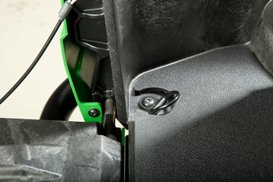 Integrated tie-down point in cargo box bed
Integrated tie-down point in cargo box bed
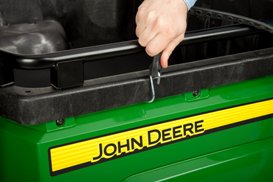 Additional tie-down points
Additional tie-down points
The cargo box offers integrated tie-down points for increased versatility. Tie-down points are located in the following areas:
- Flip-up D-shaped rings in all four corners inside the cargo-box bed
- Multiple points along the edge of the cargo box side walls
- Tie-down bars on either side of the cargo box with optional cargo box rail kit. This kit also provides a mounting system using accessories that possess the 25.4-mm (1-in.) quick clamp.
Optional accessories
 Cargo box rail system
Cargo box rail system
Optional accessories for the cargo box include:
- Factory-installed cargo box rail system
- Cargo box bed mat
- Cargo box wall extensions
Specifications
Length |
82 cm (32.3 in.) |
Width |
120.9 cm (47.6 in.) |
Depth |
29.6 cm (11.7 in.) |
Volume |
0.25 m3 (8.9 cu ft) |
Weight capacity |
227 kg (500 lb) |
Dump angle |
45 degrees |
CAUTION: Carrying extra-long cargo that extends beyond the box can adversely affect stability.
Four-wheel independent suspension provides unparalleled ride over challenging terrain and excellent handling through corners
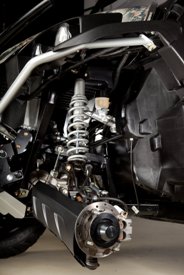 RSX front suspension detail
RSX front suspension detail
To complement the capable powertrain on the RSX860E and RSX860M, the RSX is equipped with four-wheel independent suspension. This unique suspension setup provides an unparalleled ride over challenging terrain and excellent handling through corners.
The engineering team in collaboration with engineering firms that consult with Formula 1®, NASCAR®, and INDYCAR® teams, built a sport-tuned suspension system for class-leading operator comfort, no matter the terrain, and handling that makes one think they are on rails.
Dual A-arm front suspension features include:
- Dual, wide-arch A-arm design provides maximum front-wheel control, precise steering, and maximum ground clearance out to the wheel
- 23 cm (9 in.) of travel provides ample compression and wheel extension, which keep all four wheels on the ground for superior traction and vehicle control
- Exclusive aluminum-body, high-pressure monotube shocks or piggyback shocks, both provided by FOX Racing Shox® company (see more details below)
- Solid anti-roll bar, with fully rubber isolated connecting links and pivots, is tuned to provide the most agile and predictable handling
- Camber during compression to compensate for body roll and to maintain an optimal tire contact patch for improved cornering grip
- Increasing vehicle width during compression for additional stability.
- High-strength ASTM 80-55-06 ductile cast-iron knuckle and upper A-arm to support the high stresses of the shocks, constant-velocity (CV) shaft, and wheels
- Automotive-style fully boxed and welded-steel lower A-arms to minimize unsprung mass and maximize strength
- Maintenance-free rubber torsional A-arm pivots for long life and quiet operation
- CV shaft protection from sticks that may puncture the rubber boot
- Anti-dive front suspension geometry provides a solid platform for confident braking
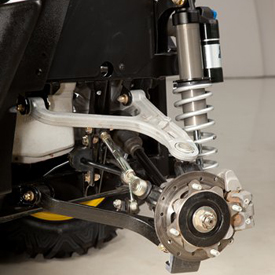 RSX rear suspension detail
RSX rear suspension detail
 Multi-link independent rear suspension (IRS)
Multi-link independent rear suspension (IRS)
Multi-link IRS rear suspension features include:
- Exclusive multi-link, semi-trailing arm rear suspension moves wheels rearward and outward in compression
- 23 cm (9 in.) (23 cm) of travel provides ample compression and wheel extension, which keep all four wheels on the ground for superior traction and vehicle control
- Exclusive aluminum-body, high-pressure monotube shocks or piggyback shocks; both provided by FOX Racing Shox (see more details below)
- Solid anti-roll bar, with fully rubber isolated connecting links and pivots, is tuned to provide the most agile and predictable handling
- Camber during compression to compensate for body roll and to maintain an optimal tire contact patch for improved cornering grip
- Increasing vehicle width during compression for additional stability.
- High-strength ASTM 80-55-06 ductile cast-iron knuckle and lower A-arm to support the high stresses of the shocks, CV shaft, and wheels with the toughness to survive impacts from boulders
- Heat-treated, aluminum-cast, upper A-arms to minimize unsprung mass
- Maintenance-free, rubber-torsional A-arm pivots for long life and quiet operation
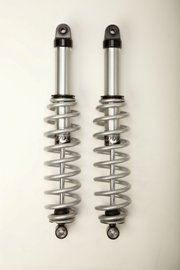 Standard FOX shocks
Standard FOX shocks
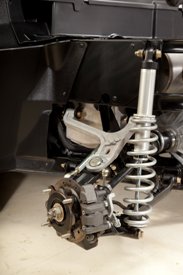 Standard FOX shocks
Standard FOX shocks
Standard equipment shocks on the base model– front and rear suspension
- Exclusive aluminum-body, high-pressure monotube FOX racing shocks
- Fully adjustable spring preload for different driving styles
- High-pressure nitrogen gas is separated from the damping oil by an internal floating piston (IFP). The separation prevents aeration (frothing) and viscosity degradation of the oil which improves damping consistency and performance fade.
- Pressure and heat generation in the monotube is less than a traditional twin-tube shock, allowing for better vehicle control in aggressive conditions.
- The single aluminum shell of the monotube design allows for more efficient heat rejection and lower overall unsprung mass.
- Mounting the shaft end of the shock to the suspension arm lowers the unsprung mass of the suspension system, leading to improved suspension response.
FOX Racing Shox is a trademark of Fox Factory, Inc. NASCAR is a trademark of NASCAR. INDYCAR is a trademark of Brickyard Trademarks Incorporated. Formula 1 is a trademark of Formula One Licensing BV, a Formula One Group Company.
12-month or 1000-hour warranty
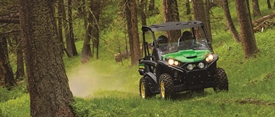 Confidence with John Deere warranty
Confidence with John Deere warranty
John Deere’s utility vehicle warranty gives the operator confidence from bumper to bumper. The model year 2018 Gator ™ RSX860 joins the rest of the current utility vehicle lineup with a 12-month or 1000-hour warranty. This gives assurance the RSX860 will be ready when it is needed the most.
Features
Delivers exhilarating acceleration and provides a top speed of 97 km/h (60 mph)
Engine, fuel, exhaust, and intake
 839-cc (51.2-cu in.) gasoline engine
839-cc (51.2-cu in.) gasoline engine
The RSX860 is powered by an 839-cc (51.2-cu in.), V-twin, four-cycle motorcycle gasoline engine. It produces 46.2 kW (62 hp*) and 80.6 Nm (59.5 lb-ft) of torque. The advanced electronic controls and fuel-injection systems deliver superb starting, idling, and throttle response during operation.
The engine offers the following performance and reliability features:
- Delivers exhilarating acceleration for excellent performance
- 97-km/h (60-mph) top speed
- Mounted transversely under the seats for a low center of gravity and more equal weight distribution between the front and rear axles
- Closed-loop electronic fuel injection for superb performance, instant throttle response, consistent performance at high altitude, and hassle-free cold-weather starting (tested to -20°F, or -29°C)
- Dual oxygen sensors provide a more accurate air-to-fuel ratio balance between cylinders, increasing ability to start and overall engine performance
- Engine control unit (ECU) cutout to protect critical drive components when the wheel speed far exceeds the vehicle speed
- Liquid cooled for quieter operation and optimal performance
- Four-valve-per-cylinder design provides greater efficiency and fuel economy
- Dry sump oiling system
- More efficiently lubricates the engine resulting in more available horsepower over a conventional wet sump design
- Oil tank is more easily accessible for checking and filling the oil
- Allows for the engine to be mounted low in the vehicle to lower the center of gravity
- Oil cooler in front of the radiator to help keep engine oil at lower operating temperatures
- Full-pressure lubrication system
- Spin-on oil filter with drain bracket and oil drain valve enable easy servicing
- High-flow air filter
- Utilizes nano-fiber technology to increase the efficiency of the filtration without sacrificing horsepower
- See-through coolant recovery tank permits the operator to check the coolant level without having to remove the radiator cap
- Sealed radiator compartment keeps trash and debris on the outside of the grille
- 450 W maximum magneto charging system
- Auto-start electronic ignition system optimizes ECU inputs for easy starting
- Electronic ignition is continuously variable for optimum engine power and provides fast, reliable starts
- Exhaust system design
- Large-diameter header pipes optimized for maximum horsepower output collect in high-volume muffler
- Full stainless steel for longevity under severe loading and heat
- Additional heat wrap ensures heat dissipation through the tail pipe
- Spark-arresting muffler is United Stated Forest Service (USFS) approved
- Large 28-L (7.4-gal.) fuel tank
- An engine isolation system dramatically reduces engine vibration and noise. Engine vibration will be reduced by 67-83 percent on the floor, and the noise will be reduced by 2-4 dB(A)
*Engine horsepower is provided by the engine manufacturer to be used for comparison purposes only. Actual operating horsepower will be less. Refer to the engine manufacturer’s website for additional information.
Large, extra-durable, one-piece cargo box ensures hard-driving performance and longevity
The cargo box consists of a high-density polyethylene copolymer composite material that eliminates rust, dents, and reduces noise. This large, one-piece design has rounded inside corners to ensure material removal when tilted. The composite box is highly ribbed and supported with a welded steel-ladder structure to ensure hard-driving performance and longevity. The three highly styled exterior pieces are made of thermoplastic polyolefin (TPO) for extra durability.
Cargo box tailgate
 Tailgate handle
Tailgate handle
 Removable tailgate
Removable tailgate
 Tailgate pivot
Tailgate pivot
 Removable lanyards
Removable lanyards
The tailgate can be opened or removed for easier cleanout and to carry longer items. It features truck-like performance and can be operated with one hand.
The tailgate’s pivot point is made of hardened steel for durability and designed for tool-less removal. The standard lanyards can also be disconnected without tools to remove the tailgate for convenient loading and unloading tasks.
Cargo box tilt and removal
 Integrated handle for manual cargo-box tilt
Integrated handle for manual cargo-box tilt
The cargo box ease of use is critical to performing tasks quickly and efficiently. Starting with the truck-style tailgate, the removal of content in this cargo box is much easier. The manual release functions as the lift lever as well, done in a smooth, one step motion. It can even be tilted from both sides of the vehicle. To reduce the overall effort of lift, the pivot point of the cargo box is closer to the center. The combination of easy-to-use attributes makes this cargo box best in class.
With the removal of two bolts, the cargo box can easily be detached from the vehicle frame for ease of servicing.
Integrated tie-down points
 Integrated tie-down point in cargo box bed
Integrated tie-down point in cargo box bed
 Additional tie-down points
Additional tie-down points
The cargo box offers integrated tie-down points for increased versatility. Tie-down points are located in the following areas:
- Flip-up D-shaped rings in all four corners inside the cargo-box bed
- Multiple points along the edge of the cargo box side walls
- Tie-down bars on either side of the cargo box with optional cargo box rail kit. This kit also provides a mounting system using accessories that possess the 25.4-mm (1-in.) quick clamp.
Optional accessories
 Cargo box rail system
Cargo box rail system
Optional accessories for the cargo box include:
- Factory-installed cargo box rail system
- Cargo box bed mat
- Cargo box wall extensions
Specifications
Length |
82 cm (32.3 in.) |
Width |
120.9 cm (47.6 in.) |
Depth |
29.6 cm (11.7 in.) |
Volume |
0.25 m3 (8.9 cu ft) |
Weight capacity |
227 kg (500 lb) |
Dump angle |
45 degrees |
CAUTION: Carrying extra-long cargo that extends beyond the box can adversely affect stability.
Four-wheel independent suspension provides unparalleled ride over challenging terrain and excellent handling through corners
 RSX front suspension detail
RSX front suspension detail
To complement the capable powertrain on the RSX860E and RSX860M, the RSX is equipped with four-wheel independent suspension. This unique suspension setup provides an unparalleled ride over challenging terrain and excellent handling through corners.
The engineering team in collaboration with engineering firms that consult with Formula 1®, NASCAR®, and INDYCAR® teams, built a sport-tuned suspension system for class-leading operator comfort, no matter the terrain, and handling that makes one think they are on rails.
Dual A-arm front suspension features include:
- Dual, wide-arch A-arm design provides maximum front-wheel control, precise steering, and maximum ground clearance out to the wheel
- 23 cm (9 in.) of travel provides ample compression and wheel extension, which keep all four wheels on the ground for superior traction and vehicle control
- Exclusive aluminum-body, high-pressure monotube shocks or piggyback shocks, both provided by FOX Racing Shox® company (see more details below)
- Solid anti-roll bar, with fully rubber isolated connecting links and pivots, is tuned to provide the most agile and predictable handling
- Camber during compression to compensate for body roll and to maintain an optimal tire contact patch for improved cornering grip
- Increasing vehicle width during compression for additional stability.
- High-strength ASTM 80-55-06 ductile cast-iron knuckle and upper A-arm to support the high stresses of the shocks, constant-velocity (CV) shaft, and wheels
- Automotive-style fully boxed and welded-steel lower A-arms to minimize unsprung mass and maximize strength
- Maintenance-free rubber torsional A-arm pivots for long life and quiet operation
- CV shaft protection from sticks that may puncture the rubber boot
- Anti-dive front suspension geometry provides a solid platform for confident braking
 RSX rear suspension detail
RSX rear suspension detail
 Multi-link independent rear suspension (IRS)
Multi-link independent rear suspension (IRS)
Multi-link IRS rear suspension features include:
- Exclusive multi-link, semi-trailing arm rear suspension moves wheels rearward and outward in compression
- 23 cm (9 in.) (23 cm) of travel provides ample compression and wheel extension, which keep all four wheels on the ground for superior traction and vehicle control
- Exclusive aluminum-body, high-pressure monotube shocks or piggyback shocks; both provided by FOX Racing Shox (see more details below)
- Solid anti-roll bar, with fully rubber isolated connecting links and pivots, is tuned to provide the most agile and predictable handling
- Camber during compression to compensate for body roll and to maintain an optimal tire contact patch for improved cornering grip
- Increasing vehicle width during compression for additional stability.
- High-strength ASTM 80-55-06 ductile cast-iron knuckle and lower A-arm to support the high stresses of the shocks, CV shaft, and wheels with the toughness to survive impacts from boulders
- Heat-treated, aluminum-cast, upper A-arms to minimize unsprung mass
- Maintenance-free, rubber-torsional A-arm pivots for long life and quiet operation
 Standard FOX shocks
Standard FOX shocks
 Standard FOX shocks
Standard FOX shocks
Standard equipment shocks on the base model– front and rear suspension
- Exclusive aluminum-body, high-pressure monotube FOX racing shocks
- Fully adjustable spring preload for different driving styles
- High-pressure nitrogen gas is separated from the damping oil by an internal floating piston (IFP). The separation prevents aeration (frothing) and viscosity degradation of the oil which improves damping consistency and performance fade.
- Pressure and heat generation in the monotube is less than a traditional twin-tube shock, allowing for better vehicle control in aggressive conditions.
- The single aluminum shell of the monotube design allows for more efficient heat rejection and lower overall unsprung mass.
- Mounting the shaft end of the shock to the suspension arm lowers the unsprung mass of the suspension system, leading to improved suspension response.
FOX Racing Shox is a trademark of Fox Factory, Inc. NASCAR is a trademark of NASCAR. INDYCAR is a trademark of Brickyard Trademarks Incorporated. Formula 1 is a trademark of Formula One Licensing BV, a Formula One Group Company.
12-month or 1000-hour warranty
 Confidence with John Deere warranty
Confidence with John Deere warranty
John Deere’s utility vehicle warranty gives the operator confidence from bumper to bumper. The model year 2018 Gator ™ RSX860 joins the rest of the current utility vehicle lineup with a 12-month or 1000-hour warranty. This gives assurance the RSX860 will be ready when it is needed the most.
Features
Powerful diesel engine delivers superb starting, idling, and throttle response
 XUV855 engine
XUV855 engine
 Remote intake and restriction indicator
Remote intake and restriction indicator
The machine is powered by an 854-cc (52.1-cu in.), 3-cylinder, liquid-cooled, four-cycle diesel engine. It produces 5.1 kgm (36.9 lb-ft) of torque at 2400 rpm.
The advanced engine delivers superb starting, idling, and throttle response during operation. With minimal noise vibration and harshness (NVH), the XUV855 is the smoothest and quietest running diesel in its class.
The engine offers the following performance and reliability features:
-
Indirect injection diesel with glow plugs ensures fast starts in cold temperatures
-
30.6 kW (22.8 hp*) at 2400 rpm
-
Overhead valve design for greater efficiency and fuel economy
-
Spin-on oil filter for easy servicing
-
Quiet operation through the entire rpm range
-
Molybdenum-coated pistons
-
High-stiffness cylinder block and gearcase
-
-
High-flow water pump and optimized water jackets maintain a steady operating temperature and eliminate hot spots
-
Full-pressure lubrication system
-
In-line mechanical fuel pump
-
Five-point, rubber isolated for quiet operation and minimal vibration
-
Dry replaceable dual-element air cleaner with remote intake and a restriction indicator
-
See-through coolant recovery tank permits the operator to check the coolant level without removing the radiator cap
-
Sealed radiator compartment keeps trash and debris on the outside of the grille
-
* The engine horsepower information is provided by the engine manufacturer to be used for comparison purposes only. The actual operating horsepower will be less.
Dual A-arm front and rear suspension provides a smooth ride over challenging terrain and excellent hauling characteristics
 XUV front suspension detail
XUV front suspension detail

To complement the most capable frame available in a high-performance utility vehicle, the XUV is equipped with four-wheel independent suspension.
A dual A-arm front and rear suspension provides a smooth ride over challenging terrain and excellent hauling characteristics.
The entire suspension system has been optimized to handle no cargo to maximum cargo without compromising ride quality or vehicle stability.
Dual A-arm front suspension features include:
-
203.2 mm (8 in.) of travel provides ample compression and wheel extension, which keep all four wheels on the ground for superior traction and vehicle control
-
17.5-mm (0.6875-in.) solid anti-roll bar with fully rubber isolated connecting links and pivots for minimal vehicle body roll and quiet operation
-
Heavy-duty, nodular cast-iron knuckles to support the strut, constant-velocity (CV) shaft, and wheel
-
Maintenance-free rubber torsional A-arm pivots for long life and quiet operation
-
CV shaft protection from sticks that may puncture the rubber boot
 XUV rear suspension detail
XUV rear suspension detail

Dual A-arm independent rear suspension features include:
-
Unequal length, dual A-arm construction for superior wheel control and travel
-
228.6 mm (9 in.) of total travel provides ample compression and wheel extension, which keep all four wheels on the ground for superior traction, excellent ride quality, and vehicle control
-
Coil-over shocks absorb the most demanding terrain
-
A-arms made from square/rectangular tubing reduce weight while remaining rigid
-
Heavy-duty, nodular cast-iron uprights support wheel loads with a double row of ball bearings
-
CV driveshaft protection from sticks that may puncture the rubber boot
-
Rear sway bar for lateral stability
Superior terrain capability
The Gator™ XUV Crossover Series Utility Vehicle has a precision-engineered drivetrain system that fully utilizes engine power, optimizing acceleration, hauling, towing, and hill-climbing capabilities. Power is transmitted from the engine through a continuously-variable clutch system to the transaxle.
Key elements of the drive system include:
Variable-speed drive
 Variable-speed drive
Variable-speed drive
The variable-speed drive consists of two clutches and a drive belt:
- Drive clutch is attached to the engine.
- Driven clutch is attached to the transaxle.
Features include:
- The engine braking system utilizes a tight belt for operation, requiring an idler sleeve on the primary clutch for neutral. The secondary clutch is a new build-on-shaft design that utilizes a cam to tune the acceleration and deceleration of the vehicle. The clutch will stay engaged, providing deceleration until approximately 5 km/h (3 mph).
- The continuously variable transmission (CVT) air intake draws in 50 percent more air versus previous designs to reduce heat and the amount of water ingestion into the CVT system. The system will reduce belt slippage and improve durability.
- A low- and high-speed forward gear offering:
- Low range is 0 km/h to 43 km/h (0 mph to 27 mph), XUV825E and XUV825M S4
- Low range is 0 km/h to 24 km/h (0 mph to 15 mph), XUV855E and XUV855M S4
- High range is 0 km/h to 71 km/h (0 mph to 44 mph), XUV825E and XUV825M S4
- High range is 0 km/h to 51 km/h (0 mph to 32 mph), XUV855E and XUV855M S4
- Ability to creep along slowly to maneuver in tight spaces
- Standard full-clutch enclosure with high speed fan provides longer belt and clutch life
- High-ratio clutches with three cam weights for maximum belt clamp load in high-torque conditions
- Powertrain reduction ratios:
- The complete reduction ratios range for high gear is 8.6:1 at top speed and 42:1 at initial clutch engagement. This varies between the vehicles listed above.
- The complete reduction ratios range for low gear is 17.9:1 at top speed and 86.8:1 at initial clutch engagement. This varies between the vehicles listed above.
NOTE: Delivery and torque to the ground depends on tire size, which is a function of nominal size and pressure.
How the variable-speed drive works:
- As engine speed increases, the spring-loaded drive clutch is closed by weights being forced out by centrifugal force.
- As the drive clutch closes, the belt rides up to the largest diameter of the drive clutch and forces open the driven clutch.
- With the belt running in the smallest diameter of the driven clutch, the speed being transferred to the transaxle is increased.
- The driven clutch is designed to sense varying loads (inclines, mud, etc.) and constantly adjusts drive speed upward or downward so that engine rpm remains optimal.
Transaxle, mechanical front-wheel drive (MFWD), and constant-velocity (CV) shafts
 Side view of CVT intake and clutch on closure (XUV855 shown)
Side view of CVT intake and clutch on closure (XUV855 shown)
 Front differential rocker switch
Front differential rocker switch
 Rear end shot of transaxle/CV shafts
Rear end shot of transaxle/CV shafts
Operator interface
-
On-demand true four-wheel drive (4WD) system with an auto-locking front differential and dash-mounted electronic rocker switch is best in class; when the rocker switch is in the on 4WD position, the front differential will automatically lock for extra traction when needed, but when the rocker switch is in the off two-wheel drive (2WD) position, the vehicle will remain in 2WD
-
Provides exceptional traction in challenging conditions
-
Maintains turf-friendly operation in 2WD mode
-
Illuminated for visibility in low-light conditions
-
Transaxle
-
Two-speed, fully-enclosed, oil bath transaxle allows for superior pulling ability
-
Cast-aluminum design is the most robust in the industry
-
Helical forward and reverse gears are used for quiet operation
-
Rear traction assist (differential lock) is built in and can be engaged on demand
-
Allows locking the rear drive wheels together
-
Provides increased traction in tough spots
-
NOTE: Differential design reduces scuffing of the turf during turns because it allows the inside wheels to turn slower than the outside wheels
-
-
Neutral start safety interlock for engine ignition system
-
Large, sealed bearings are located inside the housing for better protection and durability
-
Contains gear case for transferring power to the MFWD
-
Splined shaft interfaces for maximum torque transfer and durability
-
All drive gears machined from highest grade gear steel
-
Protected by a skid plate
-
-
MFWD
-
Electronic design is auto-locking for ease of use
-
Performs like a locking differential when engaged, but like an open differential when cornering
-
Offers positive engagement of both front wheels in forward and reverse as a differential package
-
Automatic engagement on the fly—no shift linkages required
-
-
Protected by a skid plate and frame
-
-
Drive shafts
-
Rear CV shaft diameter measures 27 mm (1.1 in.) and is designed for peak engine and braking torque
-
Front CV shaft diameter measures 23.9 mm (0.94 in.) and is designed for peak engine torque
-
Propshaft (transaxle to MFWD shaft) diameter measures 23 mm (0.91 in.) and is designed for peak engine torque
-
All CV shaft and propshaft joints are maintenance free and protected by exclusive Neoprene boots for durability
-
Extra-durable deluxe cargo box ensures hard-working performance and longevity
 Deluxe cargo box (XUV825 camo shown)
Deluxe cargo box (XUV825 camo shown)

The deluxe cargo box consists of a 15 percent glass-filled polypropylene composite material that eliminates rust, dents, and reduces noise.
Deluxe cargo box tailgate
 Tailgate handle
Tailgate handle
 Tailgate lowered to 150 degrees
Tailgate lowered to 150 degrees
The tailgate can be opened or removed for easier cleanout and to carry longer items. The tailgate has been improved, features truck-like performance, and can be operated with one hand.
The standard-installed lanyards can also be removed to lower the tailgate to 150 degrees for convenient loading and unloading tasks.
Deluxe cargo box tilt
 Integrated handle for manual cargo box tilt
Integrated handle for manual cargo box tilt

The deluxe cargo box is easier to latch, unlatch, raise, and lower with the integrated handle design and gas assist.
A prop rod is provided to hold the box in the upright position for operator convenience, as well as to limit box pivot travel.
Integrated tie-down points
 Integrated tie-down point in cargo-box bed
Integrated tie-down point in cargo-box bed
 Additional tie-down points (TH 6X4 shown)
Additional tie-down points (TH 6X4 shown)
The deluxe cargo box offers integrated tie-down points for increased versatility. Tie-down points are located in the following areas:
- Four corners inside the cargo box bed
- Four points on the load guard directly behind the operator station (A)
- Tie-down bars on either side of the cargo box (B)
- Six points on the underside of the cargo box frame (circled)
Converting deluxe cargo box to a flat bed
 Deluxe cargo box converted to a flat bed (XUV 825 shown)
Deluxe cargo box converted to a flat bed (XUV 825 shown)
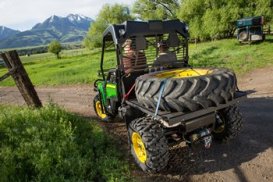 Deluxe cargo box converted to a flat bed (XUV825 shown)
Deluxe cargo box converted to a flat bed (XUV825 shown)
The deluxe cargo box easily converts to a flat bed. The flatbed configuration allows loading larger cargo.
Optional accessories
 Brake and taillight with optional protector
Brake and taillight with optional protector
 Bed mat—protects the steel floor from dents
Bed mat—protects the steel floor from dents
 Cargo box power lift
Cargo box power lift
 Cargo box power lift
Cargo box power lift
Optional accessories for the deluxe cargo box include:
- Factory-installed brake and taillight
- Factory-installed spray-in liner (not shown)
- Improves skid resistance and surface abrasion protection
- Cargo box bed mat
- Cargo box power lift
Specifications
| Length | 1143 mm (45 in.) |
| Width | 1320 mm (52 in.) |
| Depth | 304 mm (11 in.) |
| Volume | 0.46 m3 (16.4 cu ft) |
| Weight capacity | 454 kg (1000 lb) |
| Dump angle | 47 degrees |
CAUTION: Carrying extra-long cargo that extends beyond the box can adversely affect stability.
Equipped with power steering
This Gator™ XUV Crossover Utility Vehicle is equipped with power steering and a dual A-arm front suspension. These automotive-type systems exhibit excellent handling characteristics, as well as responsive steering and low steering effort:
-
Steel ball bearings secure the steering shaft and deliver smooth, responsive operation
-
Completely-sealed rack-and-pinion for long life
- Low steering ratio (lock-to-lock) provides more responsive steering and less operator input
-
Shaft U-joints are phased for a smooth, uninterrupted motion of the steering wheel
 Electric power-assist steering system
Electric power-assist steering system

Electric power-assist steering (EPAS) system has advanced features:
- Anti-kickback feature reduces the amount of steering unwinding when traversing difficult terrain.
- The system is speed sensing and adjusts steering effort as the speed of the vehicle changes.
- As speed increases, there is less steering assist for improved road feel.
- As speed decreases, steering assist increases to give lower steering efforts for improved maneuverability.
- A warning/functional light on the instrument panel provides self-diagnostics and a warning light in the situation of no assist.
- Torque sensor measures steering wheel input so the on-board computer can provide the appropriate output for various driving situations.
With the EPAS system, the operator maintains a direct, mechanical linkage from the steering wheel to the front wheels. The power-steering system interfaces mechanically with the steering system by being inserted between the steering wheel and the rack-and-pinion assembly.
A differential torque sensor is integrated into the power steering assembly. The circuit board assembly is also integral with the power-steering assembly.
Power steering does not reduce turning radius but significantly reduces steering effort by approximately 85 percent compared to those models without power steering.
EPAS interface diagram
 EPAS interface diagram
EPAS interface diagram
The numbered descriptions refer to the EPAS interface diagram shown above:
- Torque sensor
- Engine control unit (ECU)
- Fail-safe relay
- Current/thermal control circuit
- Reduction gears
- DC motor
- Rack and pinion
- Function/warning light
- Key power and ground
- Vehicle speed sensor
- Instrument cluster
- Relay module
Features
Powerful diesel engine delivers superb starting, idling, and throttle response
 XUV855 engine
XUV855 engine
 Remote intake and restriction indicator
Remote intake and restriction indicator
The machine is powered by an 854-cc (52.1-cu in.), 3-cylinder, liquid-cooled, four-cycle diesel engine. It produces 5.1 kgm (36.9 lb-ft) of torque at 2400 rpm.
The advanced engine delivers superb starting, idling, and throttle response during operation. With minimal noise vibration and harshness (NVH), the XUV855 is the smoothest and quietest running diesel in its class.
The engine offers the following performance and reliability features:
-
Indirect injection diesel with glow plugs ensures fast starts in cold temperatures
-
30.6 kW (22.8 hp*) at 2400 rpm
-
Overhead valve design for greater efficiency and fuel economy
-
Spin-on oil filter for easy servicing
-
Quiet operation through the entire rpm range
-
Molybdenum-coated pistons
-
High-stiffness cylinder block and gearcase
-
-
High-flow water pump and optimized water jackets maintain a steady operating temperature and eliminate hot spots
-
Full-pressure lubrication system
-
In-line mechanical fuel pump
-
Five-point, rubber isolated for quiet operation and minimal vibration
-
Dry replaceable dual-element air cleaner with remote intake and a restriction indicator
-
See-through coolant recovery tank permits the operator to check the coolant level without removing the radiator cap
-
Sealed radiator compartment keeps trash and debris on the outside of the grille
-
* The engine horsepower information is provided by the engine manufacturer to be used for comparison purposes only. The actual operating horsepower will be less.
Dual A-arm front and rear suspension provides a smooth ride over challenging terrain and excellent hauling characteristics
 XUV front suspension detail
XUV front suspension detail

To complement the most capable frame available in a high-performance utility vehicle, the XUV is equipped with four-wheel independent suspension.
A dual A-arm front and rear suspension provides a smooth ride over challenging terrain and excellent hauling characteristics.
The entire suspension system has been optimized to handle no cargo to maximum cargo without compromising ride quality or vehicle stability.
Dual A-arm front suspension features include:
-
203.2 mm (8 in.) of travel provides ample compression and wheel extension, which keep all four wheels on the ground for superior traction and vehicle control
-
17.5-mm (0.6875-in.) solid anti-roll bar with fully rubber isolated connecting links and pivots for minimal vehicle body roll and quiet operation
-
Heavy-duty, nodular cast-iron knuckles to support the strut, constant-velocity (CV) shaft, and wheel
-
Maintenance-free rubber torsional A-arm pivots for long life and quiet operation
-
CV shaft protection from sticks that may puncture the rubber boot
 XUV rear suspension detail
XUV rear suspension detail

Dual A-arm independent rear suspension features include:
-
Unequal length, dual A-arm construction for superior wheel control and travel
-
228.6 mm (9 in.) of total travel provides ample compression and wheel extension, which keep all four wheels on the ground for superior traction, excellent ride quality, and vehicle control
-
Coil-over shocks absorb the most demanding terrain
-
A-arms made from square/rectangular tubing reduce weight while remaining rigid
-
Heavy-duty, nodular cast-iron uprights support wheel loads with a double row of ball bearings
-
CV driveshaft protection from sticks that may puncture the rubber boot
-
Rear sway bar for lateral stability
Superior terrain capability
The Gator™ XUV Crossover Series Utility Vehicle has a precision-engineered drivetrain system that fully utilizes engine power, optimizing acceleration, hauling, towing, and hill-climbing capabilities. Power is transmitted from the engine through a continuously-variable clutch system to the transaxle.
Key elements of the drive system include:
Variable-speed drive
 Variable-speed drive
Variable-speed drive
The variable-speed drive consists of two clutches and a drive belt:
- Drive clutch is attached to the engine.
- Driven clutch is attached to the transaxle.
Features include:
- The engine braking system utilizes a tight belt for operation, requiring an idler sleeve on the primary clutch for neutral. The secondary clutch is a new build-on-shaft design that utilizes a cam to tune the acceleration and deceleration of the vehicle. The clutch will stay engaged, providing deceleration until approximately 5 km/h (3 mph).
- The continuously variable transmission (CVT) air intake draws in 50 percent more air versus previous designs to reduce heat and the amount of water ingestion into the CVT system. The system will reduce belt slippage and improve durability.
- A low- and high-speed forward gear offering:
- Low range is 0 km/h to 43 km/h (0 mph to 27 mph), XUV825E and XUV825M S4
- Low range is 0 km/h to 24 km/h (0 mph to 15 mph), XUV855E and XUV855M S4
- High range is 0 km/h to 71 km/h (0 mph to 44 mph), XUV825E and XUV825M S4
- High range is 0 km/h to 51 km/h (0 mph to 32 mph), XUV855E and XUV855M S4
- Ability to creep along slowly to maneuver in tight spaces
- Standard full-clutch enclosure with high speed fan provides longer belt and clutch life
- High-ratio clutches with three cam weights for maximum belt clamp load in high-torque conditions
- Powertrain reduction ratios:
- The complete reduction ratios range for high gear is 8.6:1 at top speed and 42:1 at initial clutch engagement. This varies between the vehicles listed above.
- The complete reduction ratios range for low gear is 17.9:1 at top speed and 86.8:1 at initial clutch engagement. This varies between the vehicles listed above.
NOTE: Delivery and torque to the ground depends on tire size, which is a function of nominal size and pressure.
How the variable-speed drive works:
- As engine speed increases, the spring-loaded drive clutch is closed by weights being forced out by centrifugal force.
- As the drive clutch closes, the belt rides up to the largest diameter of the drive clutch and forces open the driven clutch.
- With the belt running in the smallest diameter of the driven clutch, the speed being transferred to the transaxle is increased.
- The driven clutch is designed to sense varying loads (inclines, mud, etc.) and constantly adjusts drive speed upward or downward so that engine rpm remains optimal.
Transaxle, mechanical front-wheel drive (MFWD), and constant-velocity (CV) shafts
 Side view of CVT intake and clutch on closure (XUV855 shown)
Side view of CVT intake and clutch on closure (XUV855 shown)
 Front differential rocker switch
Front differential rocker switch
 Rear end shot of transaxle/CV shafts
Rear end shot of transaxle/CV shafts
Operator interface
-
On-demand true four-wheel drive (4WD) system with an auto-locking front differential and dash-mounted electronic rocker switch is best in class; when the rocker switch is in the on 4WD position, the front differential will automatically lock for extra traction when needed, but when the rocker switch is in the off two-wheel drive (2WD) position, the vehicle will remain in 2WD
-
Provides exceptional traction in challenging conditions
-
Maintains turf-friendly operation in 2WD mode
-
Illuminated for visibility in low-light conditions
-
Transaxle
-
Two-speed, fully-enclosed, oil bath transaxle allows for superior pulling ability
-
Cast-aluminum design is the most robust in the industry
-
Helical forward and reverse gears are used for quiet operation
-
Rear traction assist (differential lock) is built in and can be engaged on demand
-
Allows locking the rear drive wheels together
-
Provides increased traction in tough spots
-
NOTE: Differential design reduces scuffing of the turf during turns because it allows the inside wheels to turn slower than the outside wheels
-
-
Neutral start safety interlock for engine ignition system
-
Large, sealed bearings are located inside the housing for better protection and durability
-
Contains gear case for transferring power to the MFWD
-
Splined shaft interfaces for maximum torque transfer and durability
-
All drive gears machined from highest grade gear steel
-
Protected by a skid plate
-
-
MFWD
-
Electronic design is auto-locking for ease of use
-
Performs like a locking differential when engaged, but like an open differential when cornering
-
Offers positive engagement of both front wheels in forward and reverse as a differential package
-
Automatic engagement on the fly—no shift linkages required
-
-
Protected by a skid plate and frame
-
-
Drive shafts
-
Rear CV shaft diameter measures 27 mm (1.1 in.) and is designed for peak engine and braking torque
-
Front CV shaft diameter measures 23.9 mm (0.94 in.) and is designed for peak engine torque
-
Propshaft (transaxle to MFWD shaft) diameter measures 23 mm (0.91 in.) and is designed for peak engine torque
-
All CV shaft and propshaft joints are maintenance free and protected by exclusive Neoprene boots for durability
-
Extra-durable deluxe cargo box ensures hard-working performance and longevity
 Deluxe cargo box (XUV825 camo shown)
Deluxe cargo box (XUV825 camo shown)

The deluxe cargo box consists of a 15 percent glass-filled polypropylene composite material that eliminates rust, dents, and reduces noise.
Deluxe cargo box tailgate
 Tailgate handle
Tailgate handle
 Tailgate lowered to 150 degrees
Tailgate lowered to 150 degrees
The tailgate can be opened or removed for easier cleanout and to carry longer items. The tailgate has been improved, features truck-like performance, and can be operated with one hand.
The standard-installed lanyards can also be removed to lower the tailgate to 150 degrees for convenient loading and unloading tasks.
Deluxe cargo box tilt
 Integrated handle for manual cargo box tilt
Integrated handle for manual cargo box tilt

The deluxe cargo box is easier to latch, unlatch, raise, and lower with the integrated handle design and gas assist.
A prop rod is provided to hold the box in the upright position for operator convenience, as well as to limit box pivot travel.
Integrated tie-down points
 Integrated tie-down point in cargo-box bed
Integrated tie-down point in cargo-box bed
 Additional tie-down points (TH 6X4 shown)
Additional tie-down points (TH 6X4 shown)
The deluxe cargo box offers integrated tie-down points for increased versatility. Tie-down points are located in the following areas:
- Four corners inside the cargo box bed
- Four points on the load guard directly behind the operator station (A)
- Tie-down bars on either side of the cargo box (B)
- Six points on the underside of the cargo box frame (circled)
Converting deluxe cargo box to a flat bed
 Deluxe cargo box converted to a flat bed (XUV 825 shown)
Deluxe cargo box converted to a flat bed (XUV 825 shown)
 Deluxe cargo box converted to a flat bed (XUV825 shown)
Deluxe cargo box converted to a flat bed (XUV825 shown)
The deluxe cargo box easily converts to a flat bed. The flatbed configuration allows loading larger cargo.
Optional accessories
 Brake and taillight with optional protector
Brake and taillight with optional protector
 Bed mat—protects the steel floor from dents
Bed mat—protects the steel floor from dents
 Cargo box power lift
Cargo box power lift
 Cargo box power lift
Cargo box power lift
Optional accessories for the deluxe cargo box include:
- Factory-installed brake and taillight
- Factory-installed spray-in liner (not shown)
- Improves skid resistance and surface abrasion protection
- Cargo box bed mat
- Cargo box power lift
Specifications
| Length | 1143 mm (45 in.) |
| Width | 1320 mm (52 in.) |
| Depth | 304 mm (11 in.) |
| Volume | 0.46 m3 (16.4 cu ft) |
| Weight capacity | 454 kg (1000 lb) |
| Dump angle | 47 degrees |
CAUTION: Carrying extra-long cargo that extends beyond the box can adversely affect stability.
Features
Powerful gas engine delivers superb starting, idling, and throttle response
 812-cc (49.6-cu in.) gasoline engine
812-cc (49.6-cu in.) gasoline engine
The machine is powered by an 812-cc (49.6-cu in.), 3-cylinder, dual overhead cams, liquid-cooled, four-cycle gasoline engine. It produces 6.5 kgm (47 lb-ft) of torque at 3200 rpm. The advanced electronic controls and fuel-injection system deliver superb starting, idling, and throttle response during operation.
The engine offers the following performance and reliability features:
-
38.8 kW (52 hp*) at 6000 rpm
-
71-km/h (44-mph) top speed
-
Electronic fuel injection for superb performance, altitude adjustment, and cold-weather starting (tested to -28.9°C [-20°F])
-
Electronic ignition is continuously variable for optimum engine power and provides fast, reliable starts
-
Overhead valve design provides greater efficiency and fuel economy
-
Full-pressure lubrication system
-
Spin-on oil filter with drain bracket and oil drain plug enable easy servicing
-
Dry, replaceable, single-element air cleaner with remote intake
-
See-through coolant recovery tank permits the operator to check the coolant level without having to remove the radiator cap
-
Open radiator compartment for air flow
-
-
Standard high-capacity alternator - 85 amps for maximum accessory capability
* The engine horsepower information is provided by the engine manufacturer to be used for comparison purposes only. The actual operating horsepower will be less.
Dual A-arm front and rear suspension provides a smooth ride over challenging terrain and excellent hauling characteristics
 XUV front suspension detail
XUV front suspension detail

To complement the most capable frame available in a high-performance utility vehicle, the XUV is equipped with four-wheel independent suspension.
A dual A-arm front and rear suspension provides a smooth ride over challenging terrain and excellent hauling characteristics.
The entire suspension system has been optimized to handle no cargo to maximum cargo without compromising ride quality or vehicle stability.
Dual A-arm front suspension features include:
-
203.2 mm (8 in.) of travel provides ample compression and wheel extension, which keep all four wheels on the ground for superior traction and vehicle control
-
17.5-mm (0.6875-in.) solid anti-roll bar with fully rubber isolated connecting links and pivots for minimal vehicle body roll and quiet operation
-
Heavy-duty, nodular cast-iron knuckles to support the strut, constant-velocity (CV) shaft, and wheel
-
Maintenance-free rubber torsional A-arm pivots for long life and quiet operation
-
CV shaft protection from sticks that may puncture the rubber boot
 XUV rear suspension detail
XUV rear suspension detail

Dual A-arm independent rear suspension features include:
-
Unequal length, dual A-arm construction for superior wheel control and travel
-
228.6 mm (9 in.) of total travel provides ample compression and wheel extension, which keep all four wheels on the ground for superior traction, excellent ride quality, and vehicle control
-
Coil-over shocks absorb the most demanding terrain
-
A-arms made from square/rectangular tubing reduce weight while remaining rigid
-
Heavy-duty, nodular cast-iron uprights support wheel loads with a double row of ball bearings
-
CV driveshaft protection from sticks that may puncture the rubber boot
-
Rear sway bar for lateral stability
Superior terrain capability
The Gator™ XUV Crossover Series Utility Vehicle has a precision-engineered drivetrain system that fully utilizes engine power, optimizing acceleration, hauling, towing, and hill-climbing capabilities. Power is transmitted from the engine through a continuously-variable clutch system to the transaxle.
Key elements of the drive system include:
Variable-speed drive
 Variable-speed drive
Variable-speed drive
The variable-speed drive consists of two clutches and a drive belt:
- Drive clutch is attached to the engine.
- Driven clutch is attached to the transaxle.
Features include:
- The engine braking system utilizes a tight belt for operation, requiring an idler sleeve on the primary clutch for neutral. The secondary clutch is a new build-on-shaft design that utilizes a cam to tune the acceleration and deceleration of the vehicle. The clutch will stay engaged, providing deceleration until approximately 5 km/h (3 mph).
- The continuously variable transmission (CVT) air intake draws in 50 percent more air versus previous designs to reduce heat and the amount of water ingestion into the CVT system. The system will reduce belt slippage and improve durability.
- A low- and high-speed forward gear offering:
- Low range is 0 km/h to 43 km/h (0 mph to 27 mph), XUV825E and XUV825M S4
- Low range is 0 km/h to 24 km/h (0 mph to 15 mph), XUV855E and XUV855M S4
- High range is 0 km/h to 71 km/h (0 mph to 44 mph), XUV825E and XUV825M S4
- High range is 0 km/h to 51 km/h (0 mph to 32 mph), XUV855E and XUV855M S4
- Ability to creep along slowly to maneuver in tight spaces
- Standard full-clutch enclosure with high speed fan provides longer belt and clutch life
- High-ratio clutches with three cam weights for maximum belt clamp load in high-torque conditions
- Powertrain reduction ratios:
- The complete reduction ratios range for high gear is 8.6:1 at top speed and 42:1 at initial clutch engagement. This varies between the vehicles listed above.
- The complete reduction ratios range for low gear is 17.9:1 at top speed and 86.8:1 at initial clutch engagement. This varies between the vehicles listed above.
NOTE: Delivery and torque to the ground depends on tire size, which is a function of nominal size and pressure.
How the variable-speed drive works:
- As engine speed increases, the spring-loaded drive clutch is closed by weights being forced out by centrifugal force.
- As the drive clutch closes, the belt rides up to the largest diameter of the drive clutch and forces open the driven clutch.
- With the belt running in the smallest diameter of the driven clutch, the speed being transferred to the transaxle is increased.
- The driven clutch is designed to sense varying loads (inclines, mud, etc.) and constantly adjusts drive speed upward or downward so that engine rpm remains optimal.
Transaxle, mechanical front-wheel drive (MFWD), and constant-velocity (CV) shafts
 Side view of CVT intake and clutch on closure (XUV855 shown)
Side view of CVT intake and clutch on closure (XUV855 shown)
 Front differential rocker switch
Front differential rocker switch
 Rear end shot of transaxle/CV shafts
Rear end shot of transaxle/CV shafts
Operator interface
-
On-demand true four-wheel drive (4WD) system with an auto-locking front differential and dash-mounted electronic rocker switch is best in class; when the rocker switch is in the on 4WD position, the front differential will automatically lock for extra traction when needed, but when the rocker switch is in the off two-wheel drive (2WD) position, the vehicle will remain in 2WD
-
Provides exceptional traction in challenging conditions
-
Maintains turf-friendly operation in 2WD mode
-
Illuminated for visibility in low-light conditions
-
Transaxle
-
Two-speed, fully-enclosed, oil bath transaxle allows for superior pulling ability
-
Cast-aluminum design is the most robust in the industry
-
Helical forward and reverse gears are used for quiet operation
-
Rear traction assist (differential lock) is built in and can be engaged on demand
-
Allows locking the rear drive wheels together
-
Provides increased traction in tough spots
-
NOTE: Differential design reduces scuffing of the turf during turns because it allows the inside wheels to turn slower than the outside wheels
-
-
Neutral start safety interlock for engine ignition system
-
Large, sealed bearings are located inside the housing for better protection and durability
-
Contains gear case for transferring power to the MFWD
-
Splined shaft interfaces for maximum torque transfer and durability
-
All drive gears machined from highest grade gear steel
-
Protected by a skid plate
-
-
MFWD
-
Electronic design is auto-locking for ease of use
-
Performs like a locking differential when engaged, but like an open differential when cornering
-
Offers positive engagement of both front wheels in forward and reverse as a differential package
-
Automatic engagement on the fly—no shift linkages required
-
-
Protected by a skid plate and frame
-
-
Drive shafts
-
Rear CV shaft diameter measures 27 mm (1.1 in.) and is designed for peak engine and braking torque
-
Front CV shaft diameter measures 23.9 mm (0.94 in.) and is designed for peak engine torque
-
Propshaft (transaxle to MFWD shaft) diameter measures 23 mm (0.91 in.) and is designed for peak engine torque
-
All CV shaft and propshaft joints are maintenance free and protected by exclusive Neoprene boots for durability
-
Extra-durable deluxe cargo box ensures hard-working performance and longevity
 Deluxe cargo box (XUV825 camo shown)
Deluxe cargo box (XUV825 camo shown)

The deluxe cargo box consists of a 15 percent glass-filled polypropylene composite material that eliminates rust, dents, and reduces noise.
Deluxe cargo box tailgate
 Tailgate handle
Tailgate handle
 Tailgate lowered to 150 degrees
Tailgate lowered to 150 degrees
The tailgate can be opened or removed for easier cleanout and to carry longer items. The tailgate has been improved, features truck-like performance, and can be operated with one hand.
The standard-installed lanyards can also be removed to lower the tailgate to 150 degrees for convenient loading and unloading tasks.
Deluxe cargo box tilt
 Integrated handle for manual cargo box tilt
Integrated handle for manual cargo box tilt

The deluxe cargo box is easier to latch, unlatch, raise, and lower with the integrated handle design and gas assist.
A prop rod is provided to hold the box in the upright position for operator convenience, as well as to limit box pivot travel.
Integrated tie-down points
 Integrated tie-down point in cargo-box bed
Integrated tie-down point in cargo-box bed
 Additional tie-down points (TH 6X4 shown)
Additional tie-down points (TH 6X4 shown)
The deluxe cargo box offers integrated tie-down points for increased versatility. Tie-down points are located in the following areas:
- Four corners inside the cargo box bed
- Four points on the load guard directly behind the operator station (A)
- Tie-down bars on either side of the cargo box (B)
- Six points on the underside of the cargo box frame (circled)
Converting deluxe cargo box to a flat bed
 Deluxe cargo box converted to a flat bed (XUV 825 shown)
Deluxe cargo box converted to a flat bed (XUV 825 shown)
 Deluxe cargo box converted to a flat bed (XUV825 shown)
Deluxe cargo box converted to a flat bed (XUV825 shown)
The deluxe cargo box easily converts to a flat bed. The flatbed configuration allows loading larger cargo.
Optional accessories
 Brake and taillight with optional protector
Brake and taillight with optional protector
 Bed mat—protects the steel floor from dents
Bed mat—protects the steel floor from dents
 Cargo box power lift
Cargo box power lift
 Cargo box power lift
Cargo box power lift
Optional accessories for the deluxe cargo box include:
- Factory-installed brake and taillight
- Factory-installed spray-in liner (not shown)
- Improves skid resistance and surface abrasion protection
- Cargo box bed mat
- Cargo box power lift
Specifications
| Length | 1143 mm (45 in.) |
| Width | 1320 mm (52 in.) |
| Depth | 304 mm (11 in.) |
| Volume | 0.46 m3 (16.4 cu ft) |
| Weight capacity | 454 kg (1000 lb) |
| Dump angle | 47 degrees |
CAUTION: Carrying extra-long cargo that extends beyond the box can adversely affect stability.
Equipped with power steering
This Gator™ XUV Crossover Utility Vehicle is equipped with power steering and a dual A-arm front suspension. These automotive-type systems exhibit excellent handling characteristics, as well as responsive steering and low steering effort:
-
Steel ball bearings secure the steering shaft and deliver smooth, responsive operation
-
Completely-sealed rack-and-pinion for long life
- Low steering ratio (lock-to-lock) provides more responsive steering and less operator input
-
Shaft U-joints are phased for a smooth, uninterrupted motion of the steering wheel
 Electric power-assist steering system
Electric power-assist steering system

Electric power-assist steering (EPAS) system has advanced features:
- Anti-kickback feature reduces the amount of steering unwinding when traversing difficult terrain.
- The system is speed sensing and adjusts steering effort as the speed of the vehicle changes.
- As speed increases, there is less steering assist for improved road feel.
- As speed decreases, steering assist increases to give lower steering efforts for improved maneuverability.
- A warning/functional light on the instrument panel provides self-diagnostics and a warning light in the situation of no assist.
- Torque sensor measures steering wheel input so the on-board computer can provide the appropriate output for various driving situations.
With the EPAS system, the operator maintains a direct, mechanical linkage from the steering wheel to the front wheels. The power-steering system interfaces mechanically with the steering system by being inserted between the steering wheel and the rack-and-pinion assembly.
A differential torque sensor is integrated into the power steering assembly. The circuit board assembly is also integral with the power-steering assembly.
Power steering does not reduce turning radius but significantly reduces steering effort by approximately 85 percent compared to those models without power steering.
EPAS interface diagram
 EPAS interface diagram
EPAS interface diagram
The numbered descriptions refer to the EPAS interface diagram shown above:
- Torque sensor
- Engine control unit (ECU)
- Fail-safe relay
- Current/thermal control circuit
- Reduction gears
- DC motor
- Rack and pinion
- Function/warning light
- Key power and ground
- Vehicle speed sensor
- Instrument cluster
- Relay module
Features
Powerful gas engine delivers superb starting, idling, and throttle response
 812-cc (49.6-cu in.) gasoline engine
812-cc (49.6-cu in.) gasoline engine
The machine is powered by an 812-cc (49.6-cu in.), 3-cylinder, dual overhead cams, liquid-cooled, four-cycle gasoline engine. It produces 6.5 kgm (47 lb-ft) of torque at 3200 rpm. The advanced electronic controls and fuel-injection system deliver superb starting, idling, and throttle response during operation.
The engine offers the following performance and reliability features:
-
38.8 kW (52 hp*) at 6000 rpm
-
71-km/h (44-mph) top speed
-
Electronic fuel injection for superb performance, altitude adjustment, and cold-weather starting (tested to -28.9°C [-20°F])
-
Electronic ignition is continuously variable for optimum engine power and provides fast, reliable starts
-
Overhead valve design provides greater efficiency and fuel economy
-
Full-pressure lubrication system
-
Spin-on oil filter with drain bracket and oil drain plug enable easy servicing
-
Dry, replaceable, single-element air cleaner with remote intake
-
See-through coolant recovery tank permits the operator to check the coolant level without having to remove the radiator cap
-
Open radiator compartment for air flow
-
-
Standard high-capacity alternator - 85 amps for maximum accessory capability
* The engine horsepower information is provided by the engine manufacturer to be used for comparison purposes only. The actual operating horsepower will be less.
Dual A-arm front and rear suspension provides a smooth ride over challenging terrain and excellent hauling characteristics
 XUV front suspension detail
XUV front suspension detail

To complement the most capable frame available in a high-performance utility vehicle, the XUV is equipped with four-wheel independent suspension.
A dual A-arm front and rear suspension provides a smooth ride over challenging terrain and excellent hauling characteristics.
The entire suspension system has been optimized to handle no cargo to maximum cargo without compromising ride quality or vehicle stability.
Dual A-arm front suspension features include:
-
203.2 mm (8 in.) of travel provides ample compression and wheel extension, which keep all four wheels on the ground for superior traction and vehicle control
-
17.5-mm (0.6875-in.) solid anti-roll bar with fully rubber isolated connecting links and pivots for minimal vehicle body roll and quiet operation
-
Heavy-duty, nodular cast-iron knuckles to support the strut, constant-velocity (CV) shaft, and wheel
-
Maintenance-free rubber torsional A-arm pivots for long life and quiet operation
-
CV shaft protection from sticks that may puncture the rubber boot
 XUV rear suspension detail
XUV rear suspension detail

Dual A-arm independent rear suspension features include:
-
Unequal length, dual A-arm construction for superior wheel control and travel
-
228.6 mm (9 in.) of total travel provides ample compression and wheel extension, which keep all four wheels on the ground for superior traction, excellent ride quality, and vehicle control
-
Coil-over shocks absorb the most demanding terrain
-
A-arms made from square/rectangular tubing reduce weight while remaining rigid
-
Heavy-duty, nodular cast-iron uprights support wheel loads with a double row of ball bearings
-
CV driveshaft protection from sticks that may puncture the rubber boot
-
Rear sway bar for lateral stability
Superior terrain capability
The Gator™ XUV Crossover Series Utility Vehicle has a precision-engineered drivetrain system that fully utilizes engine power, optimizing acceleration, hauling, towing, and hill-climbing capabilities. Power is transmitted from the engine through a continuously-variable clutch system to the transaxle.
Key elements of the drive system include:
Variable-speed drive
 Variable-speed drive
Variable-speed drive
The variable-speed drive consists of two clutches and a drive belt:
- Drive clutch is attached to the engine.
- Driven clutch is attached to the transaxle.
Features include:
- The engine braking system utilizes a tight belt for operation, requiring an idler sleeve on the primary clutch for neutral. The secondary clutch is a new build-on-shaft design that utilizes a cam to tune the acceleration and deceleration of the vehicle. The clutch will stay engaged, providing deceleration until approximately 5 km/h (3 mph).
- The continuously variable transmission (CVT) air intake draws in 50 percent more air versus previous designs to reduce heat and the amount of water ingestion into the CVT system. The system will reduce belt slippage and improve durability.
- A low- and high-speed forward gear offering:
- Low range is 0 km/h to 43 km/h (0 mph to 27 mph), XUV825E and XUV825M S4
- Low range is 0 km/h to 24 km/h (0 mph to 15 mph), XUV855E and XUV855M S4
- High range is 0 km/h to 71 km/h (0 mph to 44 mph), XUV825E and XUV825M S4
- High range is 0 km/h to 51 km/h (0 mph to 32 mph), XUV855E and XUV855M S4
- Ability to creep along slowly to maneuver in tight spaces
- Standard full-clutch enclosure with high speed fan provides longer belt and clutch life
- High-ratio clutches with three cam weights for maximum belt clamp load in high-torque conditions
- Powertrain reduction ratios:
- The complete reduction ratios range for high gear is 8.6:1 at top speed and 42:1 at initial clutch engagement. This varies between the vehicles listed above.
- The complete reduction ratios range for low gear is 17.9:1 at top speed and 86.8:1 at initial clutch engagement. This varies between the vehicles listed above.
NOTE: Delivery and torque to the ground depends on tire size, which is a function of nominal size and pressure.
How the variable-speed drive works:
- As engine speed increases, the spring-loaded drive clutch is closed by weights being forced out by centrifugal force.
- As the drive clutch closes, the belt rides up to the largest diameter of the drive clutch and forces open the driven clutch.
- With the belt running in the smallest diameter of the driven clutch, the speed being transferred to the transaxle is increased.
- The driven clutch is designed to sense varying loads (inclines, mud, etc.) and constantly adjusts drive speed upward or downward so that engine rpm remains optimal.
Transaxle, mechanical front-wheel drive (MFWD), and constant-velocity (CV) shafts
 Side view of CVT intake and clutch on closure (XUV855 shown)
Side view of CVT intake and clutch on closure (XUV855 shown)
 Front differential rocker switch
Front differential rocker switch
 Rear end shot of transaxle/CV shafts
Rear end shot of transaxle/CV shafts
Operator interface
-
On-demand true four-wheel drive (4WD) system with an auto-locking front differential and dash-mounted electronic rocker switch is best in class; when the rocker switch is in the on 4WD position, the front differential will automatically lock for extra traction when needed, but when the rocker switch is in the off two-wheel drive (2WD) position, the vehicle will remain in 2WD
-
Provides exceptional traction in challenging conditions
-
Maintains turf-friendly operation in 2WD mode
-
Illuminated for visibility in low-light conditions
-
Transaxle
-
Two-speed, fully-enclosed, oil bath transaxle allows for superior pulling ability
-
Cast-aluminum design is the most robust in the industry
-
Helical forward and reverse gears are used for quiet operation
-
Rear traction assist (differential lock) is built in and can be engaged on demand
-
Allows locking the rear drive wheels together
-
Provides increased traction in tough spots
-
NOTE: Differential design reduces scuffing of the turf during turns because it allows the inside wheels to turn slower than the outside wheels
-
-
Neutral start safety interlock for engine ignition system
-
Large, sealed bearings are located inside the housing for better protection and durability
-
Contains gear case for transferring power to the MFWD
-
Splined shaft interfaces for maximum torque transfer and durability
-
All drive gears machined from highest grade gear steel
-
Protected by a skid plate
-
-
MFWD
-
Electronic design is auto-locking for ease of use
-
Performs like a locking differential when engaged, but like an open differential when cornering
-
Offers positive engagement of both front wheels in forward and reverse as a differential package
-
Automatic engagement on the fly—no shift linkages required
-
-
Protected by a skid plate and frame
-
-
Drive shafts
-
Rear CV shaft diameter measures 27 mm (1.1 in.) and is designed for peak engine and braking torque
-
Front CV shaft diameter measures 23.9 mm (0.94 in.) and is designed for peak engine torque
-
Propshaft (transaxle to MFWD shaft) diameter measures 23 mm (0.91 in.) and is designed for peak engine torque
-
All CV shaft and propshaft joints are maintenance free and protected by exclusive Neoprene boots for durability
-
Extra-durable deluxe cargo box ensures hard-working performance and longevity
 Deluxe cargo box (XUV825 camo shown)
Deluxe cargo box (XUV825 camo shown)

The deluxe cargo box consists of a 15 percent glass-filled polypropylene composite material that eliminates rust, dents, and reduces noise.
Deluxe cargo box tailgate
 Tailgate handle
Tailgate handle
 Tailgate lowered to 150 degrees
Tailgate lowered to 150 degrees
The tailgate can be opened or removed for easier cleanout and to carry longer items. The tailgate has been improved, features truck-like performance, and can be operated with one hand.
The standard-installed lanyards can also be removed to lower the tailgate to 150 degrees for convenient loading and unloading tasks.
Deluxe cargo box tilt
 Integrated handle for manual cargo box tilt
Integrated handle for manual cargo box tilt

The deluxe cargo box is easier to latch, unlatch, raise, and lower with the integrated handle design and gas assist.
A prop rod is provided to hold the box in the upright position for operator convenience, as well as to limit box pivot travel.
Integrated tie-down points
 Integrated tie-down point in cargo-box bed
Integrated tie-down point in cargo-box bed
 Additional tie-down points (TH 6X4 shown)
Additional tie-down points (TH 6X4 shown)
The deluxe cargo box offers integrated tie-down points for increased versatility. Tie-down points are located in the following areas:
- Four corners inside the cargo box bed
- Four points on the load guard directly behind the operator station (A)
- Tie-down bars on either side of the cargo box (B)
- Six points on the underside of the cargo box frame (circled)
Converting deluxe cargo box to a flat bed
 Deluxe cargo box converted to a flat bed (XUV 825 shown)
Deluxe cargo box converted to a flat bed (XUV 825 shown)
 Deluxe cargo box converted to a flat bed (XUV825 shown)
Deluxe cargo box converted to a flat bed (XUV825 shown)
The deluxe cargo box easily converts to a flat bed. The flatbed configuration allows loading larger cargo.
Optional accessories
 Brake and taillight with optional protector
Brake and taillight with optional protector
 Bed mat—protects the steel floor from dents
Bed mat—protects the steel floor from dents
 Cargo box power lift
Cargo box power lift
 Cargo box power lift
Cargo box power lift
Optional accessories for the deluxe cargo box include:
- Factory-installed brake and taillight
- Factory-installed spray-in liner (not shown)
- Improves skid resistance and surface abrasion protection
- Cargo box bed mat
- Cargo box power lift
Specifications
| Length | 1143 mm (45 in.) |
| Width | 1320 mm (52 in.) |
| Depth | 304 mm (11 in.) |
| Volume | 0.46 m3 (16.4 cu ft) |
| Weight capacity | 454 kg (1000 lb) |
| Dump angle | 47 degrees |
CAUTION: Carrying extra-long cargo that extends beyond the box can adversely affect stability.
Features
Powered by 11.6-kw (15.5-hp)*, 675-cc (41.2-cu in.), V-twin, four-cycle gas engine
 TX engine (shield removed for illustration)
TX engine (shield removed for illustration)
The Gator™ TX 4X2 is powered by an 11.6-kw (15.5-hp)*, 675-cc (41.2-cu in.), V-twin, four-cycle gas engine.
*The engine horsepower information is provided by the engine manufacturer to be used for comparison purposes only. The actual operating horsepower will be less.
The model year 2015 TX (49 state) and beyond receives evaporative emissions components to meet Environmental Protection Agency (EPA) Clean Air Act requirements.
Engine features
This engine has several performance and reliability features:
- Overhead valve design for greater efficiency and fuel economy
- Full-pressure lubrication system
- Oil filter is standard on the Gator TX 4X2 engine
- Replaceable single-element air cleaner with remote intake
- Large-capacity spark-arresting muffler
- Low fuel consumption and large 18.9 L (5 U.S. gal.) fuel tank;
fuel consumption at half load and average speed is as follows:- Gator TX 4X2: 1.3 L/h (0.35 U.S. gph)
- EPA compliant
Precision-engineered drive system
 Gator™ TS 4X2/Gator TX 4X2
Gator™ TS 4X2/Gator TX 4X2
Power is transmitted from the engine, through a continuously variable clutch system, to a transaxle. Power is transmitted from the transaxle directly to the rear axle.
Key elements of the drive system are as follows:
Variable-speed drive
The variable-speed drive consists of two clutches connected by a drive belt:
- Drive clutch is attached to and rotated by the engine.
- Driven clutch is attached to and drives the transaxle.
Features include:
- Infinite selection of speeds (0 km/h to 32 km/h [0 mph to 20 mph])
- No shifting necessary as operator increases speed
- Adjusts speed to the load to avoid bogging down when going up a hill or through challenging conditions because the wrong gear was selected
 Variable-speed drive
Variable-speed drive
How the variable-speed drive works:
- As the engine speed increases, the spring-loaded drive clutch is closed by weights being forced out by centrifugal force.
- As the drive clutch closes, the belt rides up to the largest diameter of the drive clutch and forces open the driven clutch.
- With the belt running in the smallest diameter of the driven clutch, the speed being transferred to the transaxle is increased.
- The driven clutch is designed to sense varying loads (inclines, mud, etc.) and constantly adjusts the drive speed upward or downward, so the engine rpm remains constant at constant throttle position.
Transaxle
The transaxle is fully enclosed and runs in oil for reliability.
Helical gears are used for quiet operation.
Differential design reduces scuffing of the turf during turns because the inside wheels turn slower than the outside wheels (vehicles that have a solid axle shaft must skid the inside wheel when making a turn).
Traction assist (differential lock) is built into the transaxle:
- Allows locking the rear drive wheels together
- Provides increased traction in tough spots
A neutral start safety interlock is provided for the engine ignition system.
Heavy-duty rear axle housings
Gator TS 4X2
Bolt-on cast-aluminum rear-axle housings provide an extremely strong supporting structure.
- Large, sealed bearings are located inside the housing for better protection
- Forged-splined shaft for increased torsional strength
Gator TX 4X2
One-piece forged axles are splined for maximum strength.
- Large, sealed bearings for better protection and load-carrying capabilities
- Forged-splined shaft for increased torsional strength
- Nodular cast-iron housing for increased durability
NOTE: The TS 4X2 is not sold in Australia/New Zealand.
All-wheel hydraulic disc braking with dual master cylinder
 Hydraulic disc brakes
Hydraulic disc brakes
- Four-wheel hydraulic disc brakes
- Braided stainless-steel brake lines with banjo fittings for increased durability
- Hand-lever-operated mechanical park brake system
- Integral cast-iron rotors with wheel hubs for extended life
- Automotive-style dual-circuit master cylinder with a see-through reservoir
- Larger front and rear brake calipers with sintered metallic brake pads
- Smooth-feeling engagement
Automotive-type rack and pinion steering with fully independent, single A-arm suspension
Automotive-type rack and pinion steering features include:
- Smooth, responsive operation
- Tight turning circle for excellent maneuverability
-
2.74 m (9 ft) for Gator™ TX 4X2
-
- Completely sealed for long life
Front suspension
 Automotive-type rack and pinion steering
Automotive-type rack and pinion steering
Fully independent, single A-arm suspension features include:
- 127 mm (5 in.) of total travel for better off-road control
- Spring-over-shock dampening
- Cast nodular iron 25-mm (1-in.) diameter spindles
- Automotive-type maintenance-free rubber torsional pivots for long life and quiet operation
Rear suspension
 Rear suspension
Rear suspension
The semi-independent coil over shock (COS) rear suspension system provides a softer ride.
Stable design
 Stable design
Stable design
A low center of gravity gives excellent stability.
The cargo-box load is centered over the rear wheels for balanced weight distribution.
NOTE: Shown with the optional front bumper, brush guard, and floormat.
Tires
 (A) AT tires
(A) AT tires
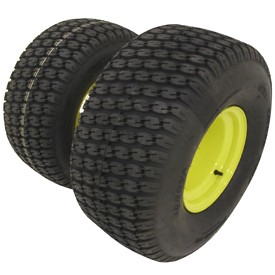 (B) Turf tires
(B) Turf tires
Four types of flotation tires are available for the Gator™ TX 4X2:
- (A) AT (all terrain) tires
- (B) Turf tires
Product attributes:
-
Both options, turf and AT, are 4-ply rated, and have an enhanced blend of material and more content that yields significantly more useful life
-
These tread patterns give a more aggressive showroom appeal
-
Each tire combines puncture resistance with a tread designed for maximum traction and performance
All tires offer a wide profile and are designed to be inflated at a low psi.
- Provides good flotation and traction in mud, sand, and other wet or soft areas
- Flexes over bumps and ruts for a smoother, more comfortable ride
- Minimizes ground compaction to save turf and prevent ruts in soft ground
| Wheels/tires | Code |
TX 4X2 |
| AT, front (two 22x9.5-10 4PR) AT, rear (two 24x10.5-10 4PR) |
1016 |
X |
| Turf, front (two 22x9.50-10 4PR) Turf, rear (two 24x12.00-10 4PR) |
1015 |
X |
NOTE: John Deere recommends that all four or six (6x4 Gator™ models) tires be the same. Although the wheel and tire sizes remain the same, current tires should not be mixed with existing tires. The existing tires will remain available to service existing Gator utility vehicles.
Features operating conveniences such as high-back seats, cup holders, 12-V outlet, glove box, and fuel gauge
 Side-by-side bucket seating
Side-by-side bucket seating
Numerous features offer the operator and passenger a comfortable ride and provide many operating conveniences.
- Side-by-side bucket seating provides room for one operator and one passenger
- Hip restraints serve as a handhold and help to keep the operator and passenger in their seats over rough terrain
- Both seats tilt forward for dry storage and ease of service
- Choice of adjustable or non-adjustable driver's seat
- Hour-meter is standard to assist in maintaining regular service intervals
- Integrated cupholders
- 12-V outlet located on instrument panel
 Convenient walk-through operator station
Convenient walk-through operator station
The control location and walk-through platform provide easy entry/exit for operator and passenger.
NOTE: Shown above with the optional front bumper, brush guard, front fender guard, and floor mat.
NOTE: The front bumper is standard on the Gator™ TH 6X4 Diesel.
- All models feature a park brake indicator light, hour-meter, and tank-mounted fuel gauge as standard equipment
- Traction assist (differential lock) is hand operated and conveniently located between the operator and passenger seats
- Traction assist indicator light (Gator TH 6X4 only)
- Glove box is located in the dash to provide a convenient storage area for small tools and the operator's manual
- Grab bar is provided for the passenger
- Center-mounted key switch
- Additional storage is provided between the seats
Equipped with rear receiver hitch
 Rear receiver hitch (shown on TX 4X2)
Rear receiver hitch (shown on TX 4X2)
The rear receiver hitch is standard equipment on the Gator™ TX 4X2 and TX Turf.
- Versatile hitch accepts a 31.75-mm (1.25-in.) drawbar
- No ball mount comes with the hitch
Durable deluxe cargo box
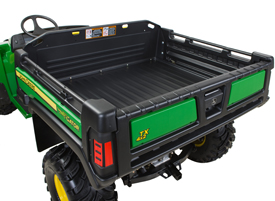 Deluxe cargo box
Deluxe cargo box
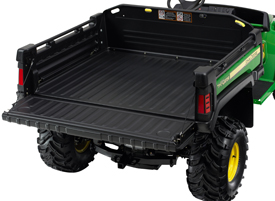 Deluxe cargo box with tailgate lowered
Deluxe cargo box with tailgate lowered
The deluxe cargo box consists of a 15 percent glass-filled polypropylene composite material that eliminates rust, dents, and reduces noise.
Deluxe cargo box tailgate
 Tailgate handle
Tailgate handle
 Tailgate lowered to 150 degrees
Tailgate lowered to 150 degrees
The tailgate can be opened or removed for easier cleanout and to carry longer items. The tailgate has been improved, features truck-like performance, and can be operated with one hand.
The standard installed lanyards can also be removed to lower the tailgate to 150 degrees for convenient loading and unloading tasks.
Deluxe cargo box tilt
 Integrated handle for manual cargo box tilt
Integrated handle for manual cargo box tilt
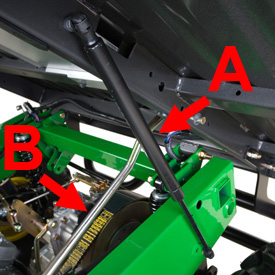 Gas assist (A) and prop rod (B)
Gas assist (A) and prop rod (B)
The deluxe cargo box is easier to latch, unlatch, raise, and lower with the integrated handle design and gas assist (A).
A prop rod (B) is provided to hold the box in the upright position for operator convenience, as well as limit box pivot travel.
Integrated tie-down points
 Integrated tie-down point in cargo box bed
Integrated tie-down point in cargo box bed
 Additional tie-down points (TH 6X4 shown)
Additional tie-down points (TH 6X4 shown)
The deluxe cargo box offers integrated tie-down points for increased versatility. Tie-down points are located in the following areas:
- Four corners inside the cargo box bed
- Four points on the load guard directly behind the operator station (A)
- Tie-down bars on either side of the cargo box (B)
- Six points on the underside of the cargo box frame (circled)
Converting deluxe cargo box to a flat bed
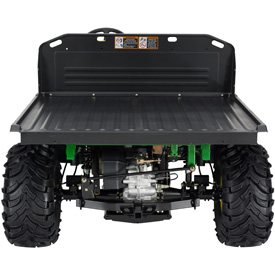 Deluxe cargo box converted to a flat bed
Deluxe cargo box converted to a flat bed
The deluxe cargo box easily converts to a flat bed. The flatbed configuration allows loading larger cargo.
Optional accessories
 Brake and taillight
Brake and taillight
 Bedmat—protects the steel floor from dents
Bedmat—protects the steel floor from dents
Optional accessories for the deluxe cargo box include:
- Factory-installed brake and taillight
- Factory-installed spray-in liner (not shown)
- Improves skid resistance and surface abrasion protection
- Cargo box bed mat
- Cargo box power lift (not shown)
Specifications
Box capacity |
|
| Volume | 465 cu L (16.4 cu ft) |
| Weight | 272 kg (600 lb) |
Box dump angles (degrees) |
|
| Manual dump | 43 degrees +/-1 |
| Power dump | 43 degrees +/-1 |
CAUTION: Carrying extra-long cargo that extends beyond the box can adversely affect stability.
Features
Precision-engineered drive system
 Gator™ TS 4X2/Gator TX 4X2
Gator™ TS 4X2/Gator TX 4X2
Power is transmitted from the engine, through a continuously variable clutch system, to a transaxle. Power is transmitted from the transaxle directly to the rear axle.
Key elements of the drive system are as follows:
Variable-speed drive
The variable-speed drive consists of two clutches connected by a drive belt:
- Drive clutch is attached to and rotated by the engine.
- Driven clutch is attached to and drives the transaxle.
Features include:
- Infinite selection of speeds (0 km/h to 32 km/h [0 mph to 20 mph])
- No shifting necessary as operator increases speed
- Adjusts speed to the load to avoid bogging down when going up a hill or through challenging conditions because the wrong gear was selected
 Variable-speed drive
Variable-speed drive
How the variable-speed drive works:
- As the engine speed increases, the spring-loaded drive clutch is closed by weights being forced out by centrifugal force.
- As the drive clutch closes, the belt rides up to the largest diameter of the drive clutch and forces open the driven clutch.
- With the belt running in the smallest diameter of the driven clutch, the speed being transferred to the transaxle is increased.
- The driven clutch is designed to sense varying loads (inclines, mud, etc.) and constantly adjusts the drive speed upward or downward, so the engine rpm remains constant at constant throttle position.
Transaxle
The transaxle is fully enclosed and runs in oil for reliability.
Helical gears are used for quiet operation.
Differential design reduces scuffing of the turf during turns because the inside wheels turn slower than the outside wheels (vehicles that have a solid axle shaft must skid the inside wheel when making a turn).
Traction assist (differential lock) is built into the transaxle:
- Allows locking the rear drive wheels together
- Provides increased traction in tough spots
A neutral start safety interlock is provided for the engine ignition system.
Heavy-duty rear axle housings
Gator TS 4X2
Bolt-on cast-aluminum rear-axle housings provide an extremely strong supporting structure.
- Large, sealed bearings are located inside the housing for better protection
- Forged-splined shaft for increased torsional strength
Gator TX 4X2
One-piece forged axles are splined for maximum strength.
- Large, sealed bearings for better protection and load-carrying capabilities
- Forged-splined shaft for increased torsional strength
- Nodular cast-iron housing for increased durability
NOTE: The TS 4X2 is not sold in Australia/New Zealand.
Features operating conveniences such as cushioned bucket seating, cup holders, 12-V outlet, glove box, and fuel gauge
 Side-by-side bucket seating
Side-by-side bucket seating
Numerous features offer the operator and passenger a comfortable ride and provide many operating conveniences.
- Side-by-side bucket seating provides room for one operator and one passenger
- Hip restraints serve as a handhold and help keep the operator and passenger in their seats over rough terrain
- Both seats tilt forward for dry storage and ease of service
- Choice of adjustable or non-adjustable driver's seat
- Hour-meter is standard to assist in maintaining regular service intervals
- Integrated cup holders
- 12-V outlet is located on the instrument panel
 Convenient walk-through operator station
Convenient walk-through operator station
The control location and walk-through platform provide easy entry/exit for the operator and passenger.
- All models feature a park brake indicator light, hour-meter, and tank-mounted fuel gauge as standard equipment
- Traction assist (differential lock) is hand operated and conveniently located between the operator and passenger seats
- Traction assist indicator light (Gator™ TH 6X4 only)
- Glove box is located in the dash to provide a convenient storage area for small tools and operator's manual
- Grab bar is provided for the passenger
- Center-mounted key switch
- Additional storage is provided between the seats
Large, durable cargo box for heavy hauling
 Large 16-gauge cargo box (Gator™ TH 6X4 shown)
Large 16-gauge cargo box (Gator™ TH 6X4 shown)
The strong, 16-gauge cargo box allows hauling heavy and bulky cargo.
The load of the box is placed directly over the rear wheels, where the load is in the most stable position. The 63.5-com (25-in.) load height for the Gator TS allows easy loading and unloading of material.
Box capacity
Gator TS |
|
Volume |
286 cu L |
Weight |
227 kg (500 lb) |
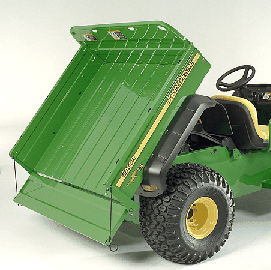 Manual-tilt cargo box (Gator TS shown)
Manual-tilt cargo box (Gator TS shown)
The cargo box can be manually tilted up to allow access to the drive system or to assist in cleaning out the box.
- A prop rod is provided to hold the box in the upright position for operator convenience.
Box dump angles (degrees)
Gator TS |
|
| Manual dump | 48.5 degrees |
| Power dump | 47.5 degrees |
The tailgate can be opened or removed for easier cleanout and to carry longer items.
The box design includes tie-downs on load guard and box sides.
CAUTION: Carrying extra-long cargo that extends beyond the box can adversely affect stability.
Features
Powered by 11.6-kW (15.5-hp)*, 675-cc (41.2-cu in.), air-cooled, V-twin, four-cycle gas engine
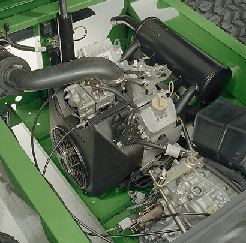 Engine (shield removed for illustration)
Engine (shield removed for illustration)
The Gator™ TH 6X4 Utility Vehicle is powered by an 11.6-kW (15.5-hp)*, 675-cc (41.2-cu in.), air-cooled, V-twin, four-cycle gas engine.
*The engine horsepower information is provided by the engine manufacturer to be used for comparison purposes only. The actual operating horsepower will be less.
Engine features
This engine has several performance and reliability features:
- Overhead valve design for greater efficiency and fuel economy
- Full-pressure lubrication system with standard filter
- Replaceable single-element air cleaner with remote intake
- Large-capacity spark-arresting muffler
- Electronic ignition for less service and fast, reliable starts
- Low fuel consumption and large 18.9 L (5 U.S. gal.) fuel tank
- Fuel consumption at half load and average speed is as follows:
Gator TH 6x4: 1.3 L/h (0.35 U.S. gph)
- Fuel consumption at half load and average speed is as follows:
- Engine is Environmental Protection Agency (EPA) compliant
Precision-engineered drive system optimizes hauling, towing, and hill-climbing capabilities
 Gator TH 6X4 drive system
Gator TH 6X4 drive system
The Gator™ TH 6X4's power is transmitted from the transaxle to the center axle. The rear axle is driven by roller chains from the center axle.
| 1. High flotation tires |
| 2. Transaxle |
| 3. Chain drive |
| 4. Engine |
| 5. Variable-speed drive |
Key elements of the drive system are as follows:
Variable-speed drive
The variable-speed drive consists of two clutches connected by a drive belt:
- Drive clutch is attached to and rotated by the engine.
- Driven clutch is attached to and drives the transaxle.
Features include:
- Infinite selection of speeds (0 km/h to 32 km/h [0 mph to 20 mph])
- No shifting necessary as operator increases speed
- Adjusts speed to the load to avoid bogging down when going up a hill or through challenging conditions because the wrong gear was selected
 Variable-speed drive
Variable-speed drive
| 1. Idle speed |
| 2. Moderate speed |
| 3. High speed |
| 4. Drive clutch |
| 5. Driven clutch |
Here is how the variable-speed drive works:
- As the engine speed increases, the spring-loaded drive clutch is closed by weights being forced out by centrifugal force.
- As the drive clutch closes, the belt rides up to the largest diameter of the drive clutch and forces open the driven clutch.
- With the belt running in the smallest diameter of the driven clutch, the speed being transferred to the transaxle is increased.
- The driven clutch is designed to sense varying loads (inclines, mud, etc.) and constantly adjusts the drive speed upward or downward, so the engine rpm remains constant at constant throttle position.
Transaxle
The transaxle is fully enclosed and runs in oil for reliability.
Helical gears are used for quiet operation.
The differential design reduces scuffing of the turf during turns because the inside wheels turn slower than the outside wheels (vehicles that have a solid axle shaft must skid the inside wheel when making a turn).
Traction assist (differential lock) is built into the transaxle:
- Allows locking the rear drive wheels together
- Provides increased traction in tough spots
The neutral start safety interlock is provided for the engine ignition system.
Bolt-on cast-aluminum rear axle housings provide an extremely strong supporting structure.
- Large, sealed bearings are located inside the housing for better protection
- Forged-splined shaft for increased torsional strength
Features operating conveniences such as high-back seats, cup holders, 12-V outlet, glove box, and fuel gauge
 Side-by-side bucket seating
Side-by-side bucket seating
Numerous features offer the operator and passenger a comfortable ride and provide many operating conveniences.
- Side-by-side bucket seating provides room for one operator and one passenger
- Hip restraints serve as a handhold and help to keep the operator and passenger in their seats over rough terrain
- Both seats tilt forward for dry storage and ease of service
- Choice of adjustable or non-adjustable driver's seat
- Hour-meter is standard to assist in maintaining regular service intervals
- Integrated cupholders
- 12-V outlet located on instrument panel
 Convenient walk-through operator station
Convenient walk-through operator station
The control location and walk-through platform provide easy entry/exit for operator and passenger.
NOTE: Shown above with the optional front bumper, brush guard, front fender guard, and floor mat.
NOTE: The front bumper is standard on the Gator™ TH 6X4 Diesel.
- All models feature a park brake indicator light, hour-meter, and tank-mounted fuel gauge as standard equipment
- Traction assist (differential lock) is hand operated and conveniently located between the operator and passenger seats
- Traction assist indicator light (Gator TH 6X4 only)
- Glove box is located in the dash to provide a convenient storage area for small tools and the operator's manual
- Grab bar is provided for the passenger
- Center-mounted key switch
- Additional storage is provided between the seats
Durable deluxe cargo box is spacious and allows for easy loading and unloading
 Deluxe cargo box (TX 4X2 shown)
Deluxe cargo box (TX 4X2 shown)
 Deluxe cargo box, tailgate lowered (TX 4X2 shown)
Deluxe cargo box, tailgate lowered (TX 4X2 shown)
The deluxe cargo box side panels and tailgate consist of a 15 percent glass-filled polypropylene composite material that eliminates rust and dents and reduces noise. The cargo box floor and load guard (front panel) are made of steel.
Deluxe cargo box tailgate
 Tailgate handle
Tailgate handle
 Tailgate lowered to 150 degrees
Tailgate lowered to 150 degrees
The tailgate can be opened or removed for easier cleanout and to carry longer items. The tailgate features a truck-like latch, and can be operated with one hand.
The standard installed lanyards can also be removed to lower the tailgate to 150 degrees for convenient loading and unloading tasks.
Deluxe cargo box tilt
 Integrated handle (B) and latch (A)
Integrated handle (B) and latch (A)
 Gas assist (C) and prop rod (D)
Gas assist (C) and prop rod (D)
The deluxe cargo box is easier to latch (A), unlatch, raise, and lower with the integrated handle design (B) and gas assist (C).
A prop rod (D) is provided to hold the box in the upright position for operator convenience, as well as limit box pivot travel.
Integrated tie-down points
 Integrated tie-down point in cargo box bed
Integrated tie-down point in cargo box bed
 Additional tie-down points on cargo box
Additional tie-down points on cargo box
The deluxe cargo box offers integrated tie-down points for increased versatility. Tie-down points are located in the following areas:
- Four corners inside the cargo box bed
- Four points on the load guard directly behind the operator station (A)
- Tie-down bars on either side of the cargo box (B)
- Six points on the underside of the cargo box frame (circled)
Converting deluxe cargo box to a flat bed
 Deluxe cargo box converted to a flat bed
Deluxe cargo box converted to a flat bed
The deluxe cargo box easily converts to a flat bed by removing ten bolts and unplugging rear lights (if equipped) at the harness pigtail at the rear of the machine. The flatbed configuration allows loading irregularly shaped cargo.
Optional accessories
 Brake and taillight
Brake and taillight
 Bedmat—protects the steel floor from dents
Bedmat—protects the steel floor from dents
Optional accessories for the deluxe cargo box include:
- Factory-installed brake and taillight
- Brake and taillight only (for back-up lights, flashers and turn signals, order deluxe light kit)
- Factory-installed spray-in liner (not shown)
- Improves skid resistance and surface abrasion protection
- Cargo box bed mat
- Cargo box power lift (not shown)
Specifications
Box capacity |
|
| Volume | 465 cu L |
| Weight TH 6X4 gas |
454 kg (1000 lb) |
| Weight TH 6X4 diesel |
550 kg (1200 lb) |
Box dump angles (degrees) |
|
| Manual dump | 43 degrees +/-1 |
| Power dump | 43 degrees +/-1 |
Cargo box load height |
63.5 cm (25 in.) |
The cargo box load height allows for easy loading and unloading.
CAUTION: Carrying extra-long cargo that extends beyond the box can adversely affect stability.
Features
Powered by 13.8-kW (18.5-hp)*, 993-cc (60.6-cu in.), 3-cylinder, liquid-cooled, four-cycle diesel engine
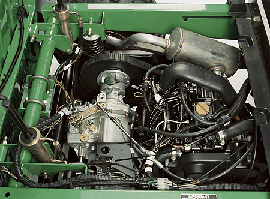 993-cc (60.6-cu in.) diesel engine
993-cc (60.6-cu in.) diesel engine
The Gator™ TH 6x4 Diesel Utility Vehicle is powered by a 13.8-kW (18.5-hp)*, 993-cc (60.6-cu in.), 3-cylinder, liquid-cooled, four-cycle diesel engine.
*The engine horsepower information is provided by the engine manufacturer to be used for comparison purposes only. The actual operating horsepower will be less.
The engine offers the following performance and reliability features:
- Overhead valve design for greater efficiency and fuel economy
- Full-pressure lubrication system with replaceable oil filter
- Dry replaceable single-element air cleaner with remote intake
- Indirect injection diesel with glow plugs insures fast starts in cold temperatures
- Spark arresting muffler (optional)
- Dual radiator system for additional cooling capacity
- Deaeration tank decreases service time and ensures coolant will be free from trapped air
- 18.9 L (5 U.S. gal.) fuel tank capacity
Dual radiator system
 Single fill point (A) and overflow bottle (B)
Single fill point (A) and overflow bottle (B)
-
Two radiators - one under the seat and one under the hood
-
Overflow bottle added under the hood
-
Single under-hood fill point for the entire cooling system
-
Increases vehicle cooling capacity by 30 percent to handle high ambient temperature conditions
-
Decreased occurrence of cooling system vapor lock by moving the front radiator to a high point in the system and having an overflow bottle
Precision-engineered drive system optimizes hauling, towing, and hill-climbing capabilities
 Gator TH 6X4 drive system
Gator TH 6X4 drive system
The Gator™ TH 6X4's power is transmitted from the transaxle to the center axle. The rear axle is driven by roller chains from the center axle.
| 1. High flotation tires |
| 2. Transaxle |
| 3. Chain drive |
| 4. Engine |
| 5. Variable-speed drive |
Key elements of the drive system are as follows:
Variable-speed drive
The variable-speed drive consists of two clutches connected by a drive belt:
- Drive clutch is attached to and rotated by the engine.
- Driven clutch is attached to and drives the transaxle.
Features include:
- Infinite selection of speeds (0 km/h to 32 km/h [0 mph to 20 mph])
- No shifting necessary as operator increases speed
- Adjusts speed to the load to avoid bogging down when going up a hill or through challenging conditions because the wrong gear was selected
 Variable-speed drive
Variable-speed drive
| 1. Idle speed |
| 2. Moderate speed |
| 3. High speed |
| 4. Drive clutch |
| 5. Driven clutch |
Here is how the variable-speed drive works:
- As the engine speed increases, the spring-loaded drive clutch is closed by weights being forced out by centrifugal force.
- As the drive clutch closes, the belt rides up to the largest diameter of the drive clutch and forces open the driven clutch.
- With the belt running in the smallest diameter of the driven clutch, the speed being transferred to the transaxle is increased.
- The driven clutch is designed to sense varying loads (inclines, mud, etc.) and constantly adjusts the drive speed upward or downward, so the engine rpm remains constant at constant throttle position.
Transaxle
The transaxle is fully enclosed and runs in oil for reliability.
Helical gears are used for quiet operation.
The differential design reduces scuffing of the turf during turns because the inside wheels turn slower than the outside wheels (vehicles that have a solid axle shaft must skid the inside wheel when making a turn).
Traction assist (differential lock) is built into the transaxle:
- Allows locking the rear drive wheels together
- Provides increased traction in tough spots
The neutral start safety interlock is provided for the engine ignition system.
Bolt-on cast-aluminum rear axle housings provide an extremely strong supporting structure.
- Large, sealed bearings are located inside the housing for better protection
- Forged-splined shaft for increased torsional strength
Features operating conveniences such as high-back seats, cup holders, 12-V outlet, glove box, and fuel gauge
 Side-by-side bucket seating
Side-by-side bucket seating
Numerous features offer the operator and passenger a comfortable ride and provide many operating conveniences.
- Side-by-side bucket seating provides room for one operator and one passenger
- Hip restraints serve as a handhold and help to keep the operator and passenger in their seats over rough terrain
- Both seats tilt forward for dry storage and ease of service
- Choice of adjustable or non-adjustable driver's seat
- Hour-meter is standard to assist in maintaining regular service intervals
- Integrated cupholders
- 12-V outlet located on instrument panel
 Convenient walk-through operator station
Convenient walk-through operator station
The control location and walk-through platform provide easy entry/exit for operator and passenger.
NOTE: Shown above with the optional front bumper, brush guard, front fender guard, and floor mat.
NOTE: The front bumper is standard on the Gator™ TH 6X4 Diesel.
- All models feature a park brake indicator light, hour-meter, and tank-mounted fuel gauge as standard equipment
- Traction assist (differential lock) is hand operated and conveniently located between the operator and passenger seats
- Traction assist indicator light (Gator TH 6X4 only)
- Glove box is located in the dash to provide a convenient storage area for small tools and the operator's manual
- Grab bar is provided for the passenger
- Center-mounted key switch
- Additional storage is provided between the seats
Durable deluxe cargo box is spacious and allows for easy loading and unloading
 Deluxe cargo box (TX 4X2 shown)
Deluxe cargo box (TX 4X2 shown)
 Deluxe cargo box, tailgate lowered (TX 4X2 shown)
Deluxe cargo box, tailgate lowered (TX 4X2 shown)
The deluxe cargo box side panels and tailgate consist of a 15 percent glass-filled polypropylene composite material that eliminates rust and dents and reduces noise. The cargo box floor and load guard (front panel) are made of steel.
Deluxe cargo box tailgate
 Tailgate handle
Tailgate handle
 Tailgate lowered to 150 degrees
Tailgate lowered to 150 degrees
The tailgate can be opened or removed for easier cleanout and to carry longer items. The tailgate features a truck-like latch, and can be operated with one hand.
The standard installed lanyards can also be removed to lower the tailgate to 150 degrees for convenient loading and unloading tasks.
Deluxe cargo box tilt
 Integrated handle (B) and latch (A)
Integrated handle (B) and latch (A)
 Gas assist (C) and prop rod (D)
Gas assist (C) and prop rod (D)
The deluxe cargo box is easier to latch (A), unlatch, raise, and lower with the integrated handle design (B) and gas assist (C).
A prop rod (D) is provided to hold the box in the upright position for operator convenience, as well as limit box pivot travel.
Integrated tie-down points
 Integrated tie-down point in cargo box bed
Integrated tie-down point in cargo box bed
 Additional tie-down points on cargo box
Additional tie-down points on cargo box
The deluxe cargo box offers integrated tie-down points for increased versatility. Tie-down points are located in the following areas:
- Four corners inside the cargo box bed
- Four points on the load guard directly behind the operator station (A)
- Tie-down bars on either side of the cargo box (B)
- Six points on the underside of the cargo box frame (circled)
Converting deluxe cargo box to a flat bed
 Deluxe cargo box converted to a flat bed
Deluxe cargo box converted to a flat bed
The deluxe cargo box easily converts to a flat bed by removing ten bolts and unplugging rear lights (if equipped) at the harness pigtail at the rear of the machine. The flatbed configuration allows loading irregularly shaped cargo.
Optional accessories
 Brake and taillight
Brake and taillight
 Bedmat—protects the steel floor from dents
Bedmat—protects the steel floor from dents
Optional accessories for the deluxe cargo box include:
- Factory-installed brake and taillight
- Brake and taillight only (for back-up lights, flashers and turn signals, order deluxe light kit)
- Factory-installed spray-in liner (not shown)
- Improves skid resistance and surface abrasion protection
- Cargo box bed mat
- Cargo box power lift (not shown)
Specifications
Box capacity |
|
| Volume | 465 cu L |
| Weight TH 6X4 gas |
454 kg (1000 lb) |
| Weight TH 6X4 diesel |
550 kg (1200 lb) |
Box dump angles (degrees) |
|
| Manual dump | 43 degrees +/-1 |
| Power dump | 43 degrees +/-1 |
Cargo box load height |
63.5 cm (25 in.) |
The cargo box load height allows for easy loading and unloading.
CAUTION: Carrying extra-long cargo that extends beyond the box can adversely affect stability.
Features
Drive system provides plenty of power to accelerate faster and climb hills better
 Drive system
Drive system
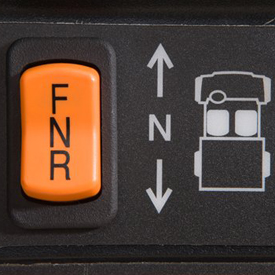 Directional change control switch
Directional change control switch
The Gator™ TE Utility Vehicle features a motor powered by a 48-V electrical system.
-
This electrical system provides plenty of power to accelerate faster, carry loads, climb hills better, and perform evenly until recharge
Through the use of a separately excited controller, the Gator TE offers the following unique features:
-
Dynamic braking
-
The motor brakes when the operator lets off the accelerator; it is not a substitute for the brakes
-
-
Overspeed control
-
Reduces exposure to high-speed situations even when descending a hill; under normal conditions with a light load, the vehicle will not freewheel down an incline
-
-
Roll away
-
The electronic brake limits the vehicle speed to approximately 3.2 km/h (2 mph) and prevents the vehicle from freewheeling down a grade when left unattended
-
-
Reduced speed in reverse
-
Controls the vehicle speed to approximately 13 km/h (8 mph) without the loss of torque
-
-
Anti-rollback
-
When stopped on a grade, this feature prevents the vehicle from freewheeling in the opposite direction of the original travel direction
-
-
Regeneration
-
Energy is transformed back into the batteries when the vehicle travels faster than the set maximum speed; regeneration also occurs when dynamic braking is engaged; an estimated 3 percent to 5 percent regenerative energy is put back into the batteries during a day of work
-
-
Diagnostics
-
An onboard computer diagnoses the electrical system; using a flashing indicator light, a sequence of flashes indicates where the controller is having problems communicating
-
-
Speed control
-
The controller is set for a vehicle speed of 24.1 km/h (15 mph)
-
-
Key-off control
-
Permits the function of the interlock and safety features with the key in the off position
-
-
Directional change control
-
When switching from forward to reverse, the machine will come to a complete stop and then changes directions; this prevents a whiplash effect and potential high stress on the drivetrain
-
Power is transferred through a transaxle with helical gearing for low gear noise.
Onboard battery charger
 Onboard battery charger (detail)
Onboard battery charger (detail)
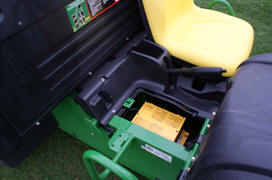 Battery charger located under passenger seat
Battery charger located under passenger seat
The Gator™ TE is equipped with an Underwriters Laboratories Inc. (UL) approved onboard charger. Located under the passenger seat, the onboard charger allows the user to charge their TE from any location containing a wall receptacle. This saves the user time, as they do not have to travel back to the maintenance area for charging; charging can be done anywhere.
The onboard charger is designed with a wide input voltage range from 85 - 265 VAC, making it capable for worldwide application. Power factor correction and 12A maximum current draw ensures the charger will work reliably from any power outlet in the world, even through surges and sags.
Improved run time
The onboard charger features advanced temperature sensor technology that improves the information flow coming in and out of charger. The batteries are allowed to charge more fully than they were ever able to before; this can improve run time by up to 75 percent (depending on use cycle).
Important safety features of the charger are as follows:
-
Vehicle ignition interlock
-
Prevents the vehicle from being driven while connected to the charger
-
-
Automatic shutoff
-
Battery charger automatically shuts off after reaching the full charge
-
External charger plug and light-emitting diode (LED) charge indicator
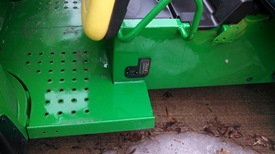
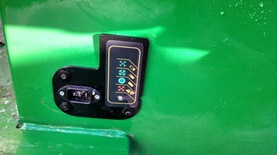
The Gator TE is equipped with an external AC input IEC connector on the driver side of the vehicle to allow the flexibility of where the charger cord is stored. There is a multicolor LED indicator for low charge, more than 80 percent charge, full charge, or fault.
Heavy-duty frame
The heavy-duty design with arc-welded uni-body construction provides strength and manufacturing tolerance control.
Features operating conveniences such as high-back cushioned seats, glove box, and automotive-style controls
 Side-by-side seating
Side-by-side seating

Many of the Gator™ TE's standard features offer the operator and passenger a smooth, comfortable ride.
-
Side-by-side seating provides room for the operator and one passenger
-
Hip restraints serve as a handhold and help to keep the operator and passenger in their seats over rough terrain
-
Professional high-back cushioned seats are position-adjustable and provide additional comfort and support
-
Both seats tilt forward for dry storage and ease of service
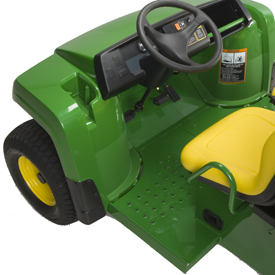 Walk-through platform
Walk-through platform

The Gator TE's controls and improved walk-through platform provide easy entry/exit for both operator and passenger.
-
Glove box is located in the dash to provide a convenient storage area for small tools and the operator's manual
-
Grab bar is provided for the passenger
-
Automotive-style controls for easy operation
-
Center-mounted key switch
-
Steering wheel is moved forward to provide more room for the operator
Durable deluxe cargo box is spacious and allows for easy loading and unloading
 Deluxe cargo box (TX 4X2 shown)
Deluxe cargo box (TX 4X2 shown)
 Deluxe cargo box, tailgate lowered (TX 4X2 shown)
Deluxe cargo box, tailgate lowered (TX 4X2 shown)
The deluxe cargo box consists of a 15 percent glass-filled polypropylene composite material that eliminates rust and dents and reduces noise.
Deluxe cargo box tailgate
 Tailgate handle
Tailgate handle
 Tailgate lowered to 150 degrees
Tailgate lowered to 150 degrees
The tailgate can be opened or removed for easier cleanout and to carry longer items. The tailgate has been improved, features truck-like performance, and can be operated with one hand.
The standard installed lanyards can also be removed to lower the tailgate to 150 degrees for convenient loading and unloading tasks.
Deluxe cargo box tilt
 Integrated handle for manual cargo-box tilt
Integrated handle for manual cargo-box tilt
 Gas assist (A) and prop rod (B) (TX 4X2 shown)
Gas assist (A) and prop rod (B) (TX 4X2 shown)
The deluxe cargo box is easier to latch, unlatch, raise, and lower with the integrated handle design and gas assist (A). Optional factory- or dealer-installed cargo box power lift is also available.
A prop rod (B) is provided to hold the box in the upright position for operator convenience, as well as limit box pivot travel.
Integrated tie-down points
 Integrated tie-down point in cargo box bed
Integrated tie-down point in cargo box bed
 Additional tie-down points (TH 6X4 shown)
Additional tie-down points (TH 6X4 shown)
The deluxe cargo box offers integrated tie-down points for increased versatility. Tie-down points are located in the following areas:
- Four corners inside the cargo box bed
- Four points on the load guard directly behind the operator station (A)
- Tie-down bars on either side of the cargo box (B)
- Six points on the underside of the cargo-box frame (circled)
Converting deluxe cargo box to a flat bed
 Deluxe cargo box converted to a flat bed
Deluxe cargo box converted to a flat bed
The deluxe cargo box easily converts to a flat bed. The flatbed configuration allows loading larger cargo.
NOTE: Cargo box shown on Gator TX. Gator TE rear axle configuration is different.
Optional accessories
 Brake and taillight
Brake and taillight
 Bedmat—protects the steel floor from dents
Bedmat—protects the steel floor from dents
Optional accessories for the deluxe cargo box include:
- Factory-installed brake and taillight
- Factory-installed spray-in liner (not shown)
- Improves skid resistance and surface abrasion protection
- Cargo box bed mat
- Cargo box power lift (not shown)
- Wide variety of attachments that connect to cargo box rails
Specifications
Box capacity |
|
| Volume | 0.46 m3 (16.4 ft3) |
| Weight | 227 kg (500 lb) |
Box dump angles (degrees) |
|
| Manual dump | 43 degrees +/-1 |
| Power dump | 43 degrees +/-1 |
CAUTION: Carrying extra-long cargo that extends beyond the box can adversely affect stability.
Features
Precision-engineered drive system optimizes acceleration, hauling, towing, and hill-climbing capabilities
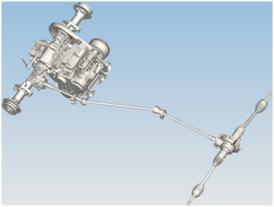 Precision-engineered drivetrain system
Precision-engineered drivetrain system
The Gator™ HPX Utility Vehicle has a precision-engineered drivetrain system to better utilize engine power and to improve acceleration, hauling, towing, and hill-climbing capabilities. Power is transmitted from the engine through a continuously-variable clutch system to the transaxle.
Key elements of the drive system include:
- Transaxle with high and low ranges, neutral, and reverse
- Engine
- Variable-speed drive
Variable-speed drive
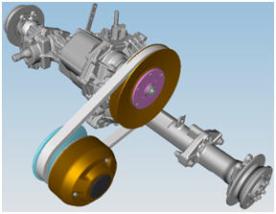 Variable-speed drive
Variable-speed drive
The variable-speed drive consists of two clutches and a drive belt:
- Drive clutch is attached to and rotated by the engine.
- Driven clutch is attached to and drives the transaxle.
How variable-speed drive works:
- As the engine speed increases, the spring-loaded drive clutch is closed by weights being forced out by centrifugal force.
- As the drive clutch closes, the belt rides up to the largest diameter of the drive clutch and forces open the driven clutch.
- With the belt running in the smallest diameter of the driven clutch, the speed being transferred to the transaxle is increased.
- The driven clutch is designed to sense varying loads (inclines, mud, etc.) and constantly adjusts drive speed upward or downward so that engine rpm remains constant at constant throttle position.
Transaxle and mechanical front-wheel drive (MFWD)
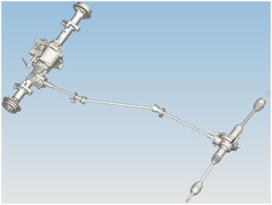 Transaxle and MFWD
Transaxle and MFWD
- Two-speed, fully-enclosed, oil bath transaxle allows superior pulling ability
- Low range is 0 km/h to 19 km/h (0 mph to 12 mph)
- High range is 0 km/h to 40 km/h (0 mph to 25 mph)
- MFWD and rear transaxle are protected by skid plates
- Helical forward and reverse gears are used for quiet operation
- On-demand four-wheel drive (4WD) system with an auto-locking front differential and dash-mounted electronic rocker switch; when the rocker switch is in the on 4WD position, the front differential will automatically lock for extra traction when needed, but when the rocker switch is in the off, two-wheel drive (2WD) position, the vehicle will remain in 2WD
-
Provides exceptional traction in challenging conditions
-
Maintains turf-friendly operation in 2WD mode
-
Combined with rear traction assist - (differential lock) can provide full, locking 4WD
-
Features operator conveniences such as high-back bucket or bench seats, cup holders, glove box, and 12-V outlet
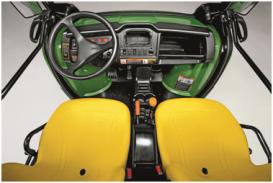 Operator's station with 457-mm (18-in.) high-back bucket seats
Operator's station with 457-mm (18-in.) high-back bucket seats
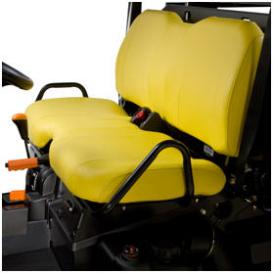 Bench seat
Bench seat
 Center console with 12-V direct current (VDC) power port
Center console with 12-V direct current (VDC) power port
The Gator™ HPX is equipped with many standard features that provide for comfortable and convenient operation:
- Side-by-side, 457-mm (18-in.) high-back bucket or bench seating provides room for one operator and one passenger
- Hip restraints serve as convenient and comfortable handholds
- Driver's seat is mounted on a slide-rail system that allows for fore-aft positioning
- Occupant protective structure (OPS) with three-point seat belts and passenger side grab handles, located on the front post, front dash, and on the outside of the seats
- Both seats (buckets only) tilt forward for ease of service and to keep them dry during outdoor storage
- Operator platform provides easy entry/exit for the operator and passenger
- Cup holders are located within reach of the operator's station
- Hour meter comes standard to assist in maintaining regular service intervals
- Traction assist (differential lock) is hand operated and conveniently located between the operator and passenger seats
- Glove box is located in the dash to provide a convenient storage area for small items
- Standard 12-VDC outlet conveniently located on the instrument panel as well as in the center console between the seats (buckets only)
- Tank-mounted fuel gauge is easily viewed from the left side of operator's seat
- Large, 76-mm (3-in.) diameter fuel tank fill opening allows easy fuel fill and helps to eliminate spillage
- Storage compartment is located under the front hood for extra storage space
- On-dash manual choke provides easy accessibility and convenient choke moderation for smooth engine warm-up (gas models only)
Heavy-duty suspension delivers excellent heavy hauling capabilities
 Heavy-duty rear suspension
Heavy-duty rear suspension
The Gator™ HPX is equipped with heavy-duty, coil-over shock, semi-independent rear suspension with 89 mm (3.5 in.) of suspension travel. This provides a comfortable ride with the cargo box unloaded while also minimizing suspension sag when the cargo box is loaded.
 Independent front suspension
Independent front suspension
The Gator HPX is equipped with a MacPherson strut, independent front suspension, providing a comfortable ride and excellent work capability. The heavy-duty, ductile cast-iron, single A-arm provides 131 mm (5.15 in.) of suspension travel for excellent handling and ride quality.
Factory-installed occupant protective structure (OPS) or deluxe cab frame
 Standard OPS with nets
Standard OPS with nets
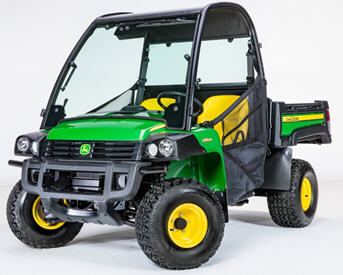 HPX815E with cab frame and nets
HPX815E with cab frame and nets
The Gator™ HPX is configured from the factory with OPS and standard occupant side retention (OSR) nets or deluxe cab frame.
- The OPS performance is certified to Society of Automotive Engineers (SAE) J219 standards.
- Glass doors can be dealer installed to complete the cab enclosure.
OSR
- Certified to American National Standards Institute (ANSI) B71.9 standards
Nets are standard equipment on the Gator HPX. Features of the nets include:
- One-handed operation
- Easy entry/exit
- Great visibility
Durable, versatile cargo box for hard-working performance
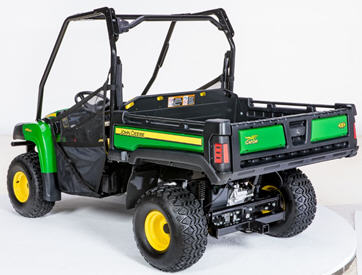
Extra-durable deluxe cargo box ensures hard-working performance and longevity
The deluxe cargo box consists of a 15 percent glass-filled polypropylene composite material that eliminates rust and dents and reduces noise.
Deluxe cargo box tailgate
 Tailgate handle
Tailgate handle
 Tailgate lowered to 150 degrees
Tailgate lowered to 150 degrees
The tailgate can be opened or removed for easier cleanout and to carry longer items. The tailgate has been improved, features truck-like performance, and can be operated with one hand.
The standard-installed lanyards can also be removed to lower the tailgate 150 degrees for convenient loading and unloading tasks.
Deluxe cargo box tilt
 Integrated handle for manual cargo box tilt
Integrated handle for manual cargo box tilt
The deluxe cargo box is easier to latch, unlatch, raise, and lower with the integrated handle design and gas assist. A prop rod is provided to hold the box in the upright position for operator convenience, as well as limit box pivot travel.
Integrated tie-down points
 Integrated tie-down point in cargo-box bed
Integrated tie-down point in cargo-box bed
 Additional tie-down points (TH 6X4 shown)
Additional tie-down points (TH 6X4 shown)
The deluxe cargo box offers integrated tie-down points for increased versatility. Tie-down points are located in the following areas:
- Four corners inside the cargo box bed
- Four points on the load guard directly behind the operator station (A)
- Tie-down bars on either side of the cargo box (B)
- Six points on the underside of the cargo box frame (circled)
Converting deluxe cargo box to a flat bed


The deluxe cargo box easily converts to a flat bed. The flatbed configuration allows operators to load larger cargo
Cargo box specifications
| Length | 1143 mm (45 in.) |
| Width | 1320 mm (52 in.) |
| Depth | 304 mm (11 in.) |
| Volume | 0.46 m3 (16.4 cu ft) |
| Weight capacity | 454 kg (1000 lb) |
| Dump angle | 47 degrees |
CAUTION: Carrying extra-long cargo that extends beyond the box can adversely affect stability.
Features
Precision-engineered drive system optimizes acceleration, hauling, towing, and hill-climbing capabilities
 Precision-engineered drivetrain system
Precision-engineered drivetrain system
The Gator™ HPX Utility Vehicle has a precision-engineered drivetrain system to better utilize engine power and to improve acceleration, hauling, towing, and hill-climbing capabilities. Power is transmitted from the engine through a continuously-variable clutch system to the transaxle.
Key elements of the drive system include:
- Transaxle with high and low ranges, neutral, and reverse
- Engine
- Variable-speed drive
Variable-speed drive
 Variable-speed drive
Variable-speed drive
The variable-speed drive consists of two clutches and a drive belt:
- Drive clutch is attached to and rotated by the engine.
- Driven clutch is attached to and drives the transaxle.
How variable-speed drive works:
- As the engine speed increases, the spring-loaded drive clutch is closed by weights being forced out by centrifugal force.
- As the drive clutch closes, the belt rides up to the largest diameter of the drive clutch and forces open the driven clutch.
- With the belt running in the smallest diameter of the driven clutch, the speed being transferred to the transaxle is increased.
- The driven clutch is designed to sense varying loads (inclines, mud, etc.) and constantly adjusts drive speed upward or downward so that engine rpm remains constant at constant throttle position.
Transaxle and mechanical front-wheel drive (MFWD)
 Transaxle and MFWD
Transaxle and MFWD
- Two-speed, fully-enclosed, oil bath transaxle allows superior pulling ability
- Low range is 0 km/h to 19 km/h (0 mph to 12 mph)
- High range is 0 km/h to 40 km/h (0 mph to 25 mph)
- MFWD and rear transaxle are protected by skid plates
- Helical forward and reverse gears are used for quiet operation
- On-demand four-wheel drive (4WD) system with an auto-locking front differential and dash-mounted electronic rocker switch; when the rocker switch is in the on 4WD position, the front differential will automatically lock for extra traction when needed, but when the rocker switch is in the off, two-wheel drive (2WD) position, the vehicle will remain in 2WD
-
Provides exceptional traction in challenging conditions
-
Maintains turf-friendly operation in 2WD mode
-
Combined with rear traction assist - (differential lock) can provide full, locking 4WD
-
Features operator conveniences such as high-back bucket or bench seats, cup holders, glove box, and 12-V outlet
 Operator's station with 457-mm (18-in.) high-back bucket seats
Operator's station with 457-mm (18-in.) high-back bucket seats
 Bench seat
Bench seat
 Center console with 12-V direct current (VDC) power port
Center console with 12-V direct current (VDC) power port
The Gator™ HPX is equipped with many standard features that provide for comfortable and convenient operation:
- Side-by-side, 457-mm (18-in.) high-back bucket or bench seating provides room for one operator and one passenger
- Hip restraints serve as convenient and comfortable handholds
- Driver's seat is mounted on a slide-rail system that allows for fore-aft positioning
- Occupant protective structure (OPS) with three-point seat belts and passenger side grab handles, located on the front post, front dash, and on the outside of the seats
- Both seats (buckets only) tilt forward for ease of service and to keep them dry during outdoor storage
- Operator platform provides easy entry/exit for the operator and passenger
- Cup holders are located within reach of the operator's station
- Hour meter comes standard to assist in maintaining regular service intervals
- Traction assist (differential lock) is hand operated and conveniently located between the operator and passenger seats
- Glove box is located in the dash to provide a convenient storage area for small items
- Standard 12-VDC outlet conveniently located on the instrument panel as well as in the center console between the seats (buckets only)
- Tank-mounted fuel gauge is easily viewed from the left side of operator's seat
- Large, 76-mm (3-in.) diameter fuel tank fill opening allows easy fuel fill and helps to eliminate spillage
- Storage compartment is located under the front hood for extra storage space
- On-dash manual choke provides easy accessibility and convenient choke moderation for smooth engine warm-up (gas models only)
Heavy-duty suspension delivers excellent heavy hauling capabilities
 Heavy-duty rear suspension
Heavy-duty rear suspension
The Gator™ HPX is equipped with heavy-duty, coil-over shock, semi-independent rear suspension with 89 mm (3.5 in.) of suspension travel. This provides a comfortable ride with the cargo box unloaded while also minimizing suspension sag when the cargo box is loaded.
 Independent front suspension
Independent front suspension
The Gator HPX is equipped with a MacPherson strut, independent front suspension, providing a comfortable ride and excellent work capability. The heavy-duty, ductile cast-iron, single A-arm provides 131 mm (5.15 in.) of suspension travel for excellent handling and ride quality.
Factory-installed occupant protective structure (OPS) or deluxe cab frame
 Standard OPS with nets
Standard OPS with nets
 HPX815E with cab frame and nets
HPX815E with cab frame and nets
The Gator™ HPX is configured from the factory with OPS and standard occupant side retention (OSR) nets or deluxe cab frame.
- The OPS performance is certified to Society of Automotive Engineers (SAE) J219 standards.
- Glass doors can be dealer installed to complete the cab enclosure.
OSR
- Certified to American National Standards Institute (ANSI) B71.9 standards
Nets are standard equipment on the Gator HPX. Features of the nets include:
- One-handed operation
- Easy entry/exit
- Great visibility
Durable, versatile cargo box for hard-working performance

Extra-durable deluxe cargo box ensures hard-working performance and longevity
The deluxe cargo box consists of a 15 percent glass-filled polypropylene composite material that eliminates rust and dents and reduces noise.
Deluxe cargo box tailgate
 Tailgate handle
Tailgate handle
 Tailgate lowered to 150 degrees
Tailgate lowered to 150 degrees
The tailgate can be opened or removed for easier cleanout and to carry longer items. The tailgate has been improved, features truck-like performance, and can be operated with one hand.
The standard-installed lanyards can also be removed to lower the tailgate 150 degrees for convenient loading and unloading tasks.
Deluxe cargo box tilt
 Integrated handle for manual cargo box tilt
Integrated handle for manual cargo box tilt
The deluxe cargo box is easier to latch, unlatch, raise, and lower with the integrated handle design and gas assist. A prop rod is provided to hold the box in the upright position for operator convenience, as well as limit box pivot travel.
Integrated tie-down points
 Integrated tie-down point in cargo-box bed
Integrated tie-down point in cargo-box bed
 Additional tie-down points (TH 6X4 shown)
Additional tie-down points (TH 6X4 shown)
The deluxe cargo box offers integrated tie-down points for increased versatility. Tie-down points are located in the following areas:
- Four corners inside the cargo box bed
- Four points on the load guard directly behind the operator station (A)
- Tie-down bars on either side of the cargo box (B)
- Six points on the underside of the cargo box frame (circled)
Converting deluxe cargo box to a flat bed


The deluxe cargo box easily converts to a flat bed. The flatbed configuration allows operators to load larger cargo
Cargo box specifications
| Length | 1143 mm (45 in.) |
| Width | 1320 mm (52 in.) |
| Depth | 304 mm (11 in.) |
| Volume | 0.46 m3 (16.4 cu ft) |
| Weight capacity | 454 kg (1000 lb) |
| Dump angle | 47 degrees |
CAUTION: Carrying extra-long cargo that extends beyond the box can adversely affect stability.
Features
Crank-adjust depth control available
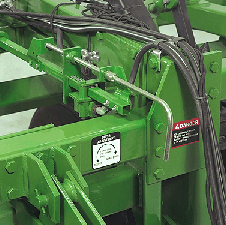 Simple, one-location depth control
Simple, one-location depth control

The crank-adjust single-point depth control is standard equipment on all models and offers the following benefits:
- More precise adjustment when changing the operating depth
- Easy access at the front of the machine
- Accurate, repeatable depth control
Simple gang depth adjustment
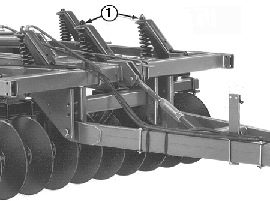 Mechanical depth adjustment
Mechanical depth adjustment

The three-bar disk gang model features a mechanical depth adjustment:
- Depth adjuster bolts (1) allow adjustment of individual gangs up or down within a 140-mm (5.5-in.) range.
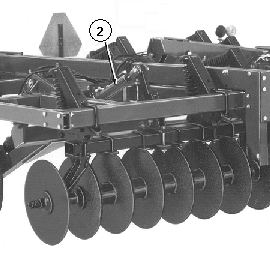 Hydraulic depth adjustment
Hydraulic depth adjustment

An optional hydraulic depth adjustment (2) is available:
- Allows on-the-go hydraulic adjustments to be made from the tractor seat
- Gangs adjust up or down within a 140-mm (5.5-in.) range
Three-bar frames offer strength
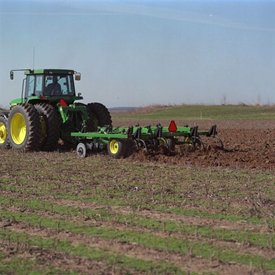 Three-bar frame of the 714 Mulch Tiller
Three-bar frame of the 714 Mulch Tiller
The three-bar frame:
-
Is constructed of three ranks of standards
- Has strength to match higher horsepower tractors
- Handles heavier residue levels
Three-bar frame models have these strength features:
- One-piece welded construction
- Solid steel in rear mainframe member
- 102-mm x 102-mm (4-in. x 4-in.) cross members
- 51-mm x 102-mm (2-in. x 4-in.) side members
- 76-mm x 127-mm (3-in. x 5-in.) diagonal frame supports
Long, narrow hitch for good maneuverability in tight headlands
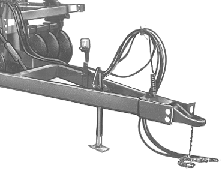 714 long, narrow hitch
714 long, narrow hitch
The long narrow hitch design:
- Allows good maneuverability in tight headlands
- Is constructed of 51-mm x 127-mm (2-in. x 5-in.) steel tubing for strength
- Heavy cast-steel hitch link for yoke-type drawbars is standard equipment
- Hitch clevis is available for use with straight drawbars (not recommended for tractors over 150 engine hp)
A Level-lift™ linkage with easy turnbuckle leveling enables the mulch tiller to remain level whether in transport or in the field position.
A hitch jack is included with all models for storage and easier hookup to the tractor.
Coulter gangs
 Coulter gangs
Coulter gangs

Coulter blades are for use where little incorporation is desired or for erosion-prone areas where it is important to disturb as little residue as possible. Blades are on 229-mm (9-in.) spacing to reduce the chance of plugging.
- Two-position blade down-pressure adjustment ensures consistent blade down pressure in light- or heavy-residue conditions.
- Coulter gangs have rigid scraper bars.
- Dura-Flex™ bearings and welded steel spools provide reliable performance and durability.
- Gangs are spring-cushioned with 140 mm (5.5 in.) of vertical travel to provide protection against rocks or other obstructions.
Choice of rigid, spring-reset, or Tru-Depth™ standards
 714 Mulch Tiller standards
714 Mulch Tiller standards
Rigid standard (figure 1):
-
In base equipment on all models
-
32 mm x 51 mm x 813 mm (1.25 in. x 2 in. x 32 in.)
-
Economical design is suited for fields having few obstructions
-
Till to a maximum depth of 279 mm (11 in.)
-
Good clearance to handle heavy trash
-
813 mm (32 in.) of underframe clearance
-
381-mm (15-in.) center-to-center spacing
-
Spring-reset 813-mm (32-in.) standard (figure 2):
- Optional on all models
- 32 mm x 51 mm x 813 mm (1.25 in. x 2 in. x 32 in.)
- Suited for fields having rocks or other obstructions
- Till to a maximum depth of 279 mm (11 in.)
- Trip height of 254 mm (10 in.) for good clearance
- 296-kg (650-lb) trip force
- Automatically resets to the original working position after clearing an obstruction
- Good clearance to handle heavy trash
- 813 mm (32 in.) of underframe clearance
- 381-mm (15-in.) center-to-center spacing
Tru-Depth standard (figure 3):
- Optional on all models
- 51 mm x 32 mm x 813 mm (2 in. x 1.25 in. x 32 in.)
- Edge bent for extra strength
- Designed to work in rocky ground and heavy draft conditions
- Till to a maximum depth of 279 mm (11 in.)
- Trip height of 279 mm (11 in.) for excellent clearance
- 568-kg (1250-lb) trip force
- Once an obstruction is cleared, the standard automatically returns to its original working position
- Excellent clearance to handle heavy trash
- 813 mm (32 in.) of underframe clearance
- 381-mm (15-in.) center-to-center spacing
Variety of ground-engaging tools available to match conditions
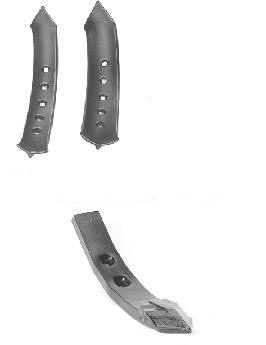 Shovels and points
Shovels and points
A variety of shovels are available to match conditions:
- 76-mm x 610-mm (3-in. x 24-in.) concave twisted shovels for use in a wide range of average soil conditions are base equipment.
- 102-mm x 610-mm (4-in. x 24-in.) concave twisted shovels for use in light, sandy soils or where greater fracturing between the standards is desired, are optional equipment.
- 51-mm x 305-mm (2-in. x 12-in.) chrome carbide point chisel provides excellent strength and wear life in tough-to-penetrate conditions.
Remaining residue cover
Typical percents of residue cover remaining are listed in the table. The percentages do not take into account variables such as the condition of the residue, speed and soil type.
Starting residue cover (percent) |
Remaining non-fragile* residue cover (percent) |
Remaining fragile** residue cover (percent) |
||||
|
with 2-in. x 14-in. shovel |
with 3-in. x 24-in. shovel |
with 4-in. x 24-in. shovel |
with 2-in. x 14-in. shovel |
with 3-in. x 24-in. shovel |
with 4-in. x 24-in. shovel |
100 |
65 |
55 |
50 |
45 |
40 |
35 |
90 |
55 |
50 |
45 |
40 |
35 |
30 |
80 |
50 |
45 |
40 |
35 |
30 |
28 |
70 |
45 |
38 |
35 |
30 |
28 |
25 |
60 |
40 |
33 |
30 |
27 |
25 |
20 |
50 |
32 |
27 |
25 |
22 |
20 |
17 |
40 |
25 |
22 |
20 |
18 |
15 |
14 |
*Non-fragile residue includes crops like corn, sorghum, wheat (more than 45 bu).
**Fragile residue includes crops like soybeans, edible beans, peas, wheat (under 45 bu), sunflower, peanuts, cotton.
Features
High clearance handles heavy residue levels
 Frame clearance for residue
Frame clearance for residue
Excellent fore-aft and vertical clearance between standards (arrows above) allows the soil and residue to freely flow through the plow:
- Both rigid and flex plows are designed to handle tall and heavy residue levels.
Clearance
Fore and aft |
Vertical |
|
|
864 mm (34 in.) |
851 mm (33.5 in.) |
Adjustable width of cut
The operator can change the plow's width of cut to match the tractor horsepower and soil conditions.
-
Narrow in tough soil
-
Wider in lighter soil
3710 Rigid Plow
The rigid plow has a width-of-cut range of 356 mm to 559 mm (14 in. to 22 in.) on land and 508 mm to 559 mm (20 in. to 22 in.) in furrow.
- Economical manual adjustment (turnbuckle is standard equipment)
- Convenient hydraulic cylinder adjustment is optional
- Pointer and decal allow returning to a predetermined width of cut
3710 Flex Plow
 3710 Flex Plow
3710 Flex Plow
The flex plow has 356 mm to 559 mm (14 in. to 22 in.) of cut.
Adjustments are made by adjusting two turnbuckles (arrows) to a predetermined length specified in the operator's manual.
Scissor-type landing helps with tight turns on rigid models
The rigid model uses a scissor-type landing adjustment to set the first bottom in relationship to the rear tractor tire for the different widths of cut:
-
Design uses minimum space, gives a clean-style appearance, and has a full range of adjustment.
-
Economical turnbuckle is used to make the adjustment.
-
Operator-supplied 76-mm x 203-mm (3-in. x 8-in.) American Society of Agricultural Engineers (ASAE) tie-bolt hydraulic cylinder may be used in place of a turnbuckle for in-furrow applications.
Land wheels on rigid models are tied to the Adjust-O-Cut bar for automatic setting for each width of cut
 Depth stops are used for easy adjustment of depth
Depth stops are used for easy adjustment of depth
Land wheels help to stabilize the plow in both the working and transport positions. They also control the depth of plowing and work in conjunction with raising and lowering the plow.
Land wheels on rigid plows are tied to the Adjust-O-Cut bar for automatic setting for each width of cut.
A single wheel is standard on the six-bottom model; dual wheels are standard on the seven- and eight-bottom models and optional on the six-bottom model (recommended in softer soils).
-
Provides good trailing characteristics in transport.
Flex models are equipped with dual, staggered Walk-Over™ land wheels
Land wheels on flex plows have four adjustment positions (arrow) to allow setting the assembly for 406-mm, 457-mm, or 508-mm (16-in., 18-in., or 20-in.) widths of cut or transport:
- Depth stops are used for easy adjustment of the depth.
Dual, staggered Walk-Over wheels are standard on flex plows:
- Allow the plow to trail like a cart
- Distribute weight evenly between both wheels
- Minimize bulldozing in soft soil
- Allow better residue flow
- Walk over obstacles and across dead furrows
Spring-reset standards available to work non-stop in rocks
The double-pivot design of the spring-reset standard uses tension spring force to return the standard to the working position.
- For heavier-duty applications
- Positive reset
- Non-adjustable trip force; factory set at 2727-kg (6000-lb) nominal
- Floats over buried rock
- Unhooks from ledge rock
Safety-trip standards for normal plowing conditions
Safety-trip standards provide an economical means for protection—suited for areas without rocks:
- No backing to reset, just raise
- Shim-adjustable trip force
- 2727-kg (6000-lb) nominal trip force (set at the factory)
- Smooth surfaces for good residue flow
- Few moving parts equals high reliability
Light-draft NU bottoms permit high-speed plowing
The NU bottoms are set behind the mainframe to prevent the mainframe from becoming a pinch-point for residue. They are designed for light draft and high-speed plowing.
- Operators often find they can plow a gear higher than with competitive plows
- Greater productivity and fuel economy
- Speeds up to 10 km/h (6 mph)
Available in 400-mm (16-in.) and 450-mm (18-in.) sizes with an unpolished finish.
The maximum plowing depth are as follows:
Bottom maximum |
Plowing depth* |
|---|---|
400 mm (16 in.) |
305 mm (12 in.) |
450 mm (18 in.) |
356 mm (14 in.) |
* In some soil conditions at plowing depths in the 254-mm to 356-mm (10-in. to 14-in.) range, soil may boil over the moldboard, resulting in poorly defined furrows.
Shares for NU bottoms
Both the NU 400 and the NU 450 come standard with heavy-duty, full-cut shares.
 Variety of shares
Variety of shares
A variety of shares are available through Parts to match the plowing conditions:
Image |
Part |
Description |
1 |
NU400 | Regular, narrow cut |
2 |
NU400 | Heavy duty, narrow cut |
3 |
NU400 | Heavy duty, full cut |
4 |
NU450 | Heavy duty, narrow cut |
5 |
NU450 | Heavy duty, full cut (standard equipment) |
6 |
NU450 | 500-mm over-cut (for use when wide widths of cut or complete slicing is required) |
7 |
NU450 | Hard-faced gumbo (for heavy soil conditions when penetration is a problem |
8 |
NU400 | Hard-faced (for areas where abrasive soil causes rapid wear of heavy-duty shares—not for use in rocks) |
9 |
NU450 | Hard-faced (for areas where abrasive soil causes rapid wear of heavy-duty shares—not for use in rocksfor) |
The gumbo moldboard (A32211) is available for NU 400 bottom and is recommended for use in heavy soil (gumbo) conditions. It is similar to the NU 400 bottom except that it has less area at the wing tip.
- Moldboard will not be forced upward by soil movement as much as NU 400.
- Permits soil to push off easier for better scouring and lighter draft.
John Deere furnishes a replacement share for any John Deere plow share that breaks before the share reaches the following wear limits (labor not included; wear to be measured perpendicularly across the middle of the front bolt hole):
- 13-mm (1/2-in.) wear, 89 mm (3.5 in.) remaining.
Trashboards for NU bottoms
 Trashboard
Trashboard

Plastic or steel trashboards can be added to NU bottoms to improve coverage in tall, heavy residue. Plastic trashboards are only recommended for non-abrasive soils where scouring is a problem with steel trashboards.
Shear-bolt coulters suited for areas without rocks
 Shear-bolt coulters
Shear-bolt coulters
Economical design of the shear-bolt coulters is suited for areas without rocks:
- Few moving parts
- Good depth adjustment range
- Good lateral adjustment range
Adjustable-force cushion coulters available for rocky or normal field conditions
Adjustable-force cushion coulters are suited for rocky or normal field conditions:
- Excellent rosette depth adjustment range
- Good lateral adjustment range
- Separate down-force adjustment
- Overload protection to prevent damage
Features
V-style mainframe distributes weight for good penetration
 995 mainframe
995 mainframe
The V-style mainframe of the 995 Moldboard Plow distributes weight for good penetration.
The mainframe is made of high-strength 178-mm x 102-mm (7-in. x 4-in.) tubing that is 8-mm (5/16-in.) thick to handle the stress of high-horsepower tractors working in tough ground conditions.
Moldboard frame pivots with the bottoms
 Moldboard frame
Moldboard frame
All 995 Moldboard Plows use only one set of bottoms.
The moldboards are reversed laterally by a hydraulic cylinder that is standard equipment. There are several advantages of this design over traditional two-way roll-over plows with two sets of bottoms:
- Requires less 3-point hitch capacity
- Requires less ballasting of the tractor front end
- Eliminates initial cost and service requirements for one complete set of standards and bottoms
Integral on-land hitch provides excellent maneuverability
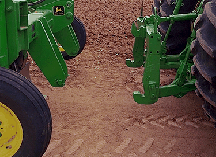 Integral on-land hitch
Integral on-land hitch

The integral hitch gives unexcelled maneuverability in turns and when parking in tight areas:
- Category 3/3N Quik-Coupler compatible
- Tractor rockshaft lever controls the raising and lowering of the plow
- Maximum plowing depth to 356 mm (14 in.)
- Provides ample clearance between the tractor tires and the plow
Adjust front gauge wheels to limit plowing depth
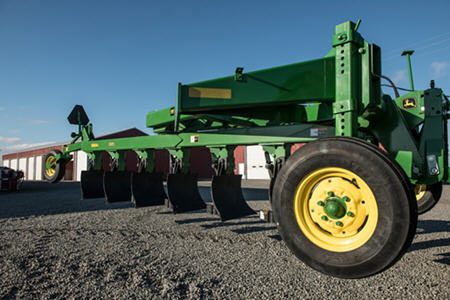 Front gauge wheels
Front gauge wheels
The front gauge wheels can be adjusted to limit the plowing depth to 356 mm (14 in.). They come equipped with 6.70-15 tires.
Rear gauge wheels come in standard equipment
 995 Moldboard Plow rear gauge wheels
995 Moldboard Plow rear gauge wheels

Two front and one rear gauge wheels are standard equipment on the 995 Moldboard Plow:
- Equipped with 6.70-15 tires for good flotation
- Easy turnbuckle adjustment on rear gauge wheel
- Adjustable front gauge wheels limit the plowing depth to 356 mm (14 in.)
Features
Moldboard frame pivots with the bottoms
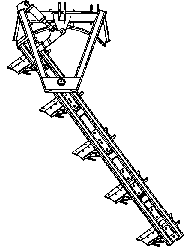 975 mainframe
975 mainframe
All 975 Moldboard Plows use only one set of bottoms.
The moldboards are reversed laterally by a hydraulic cylinder that is standard equipment. There are several advantages of this design over traditional two-way rollover plows with two sets of bottoms:
- Requires less 3-point hitch capacity
- Requires less ballasting of the tractor front end
- Eliminates initial cost and service requirements for one complete set of standards and bottoms
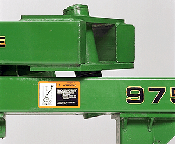 Reversing pin
Reversing pin

The reversing pin is positioned at a 13.5-degree angle, instead of being straight up, for even plowing in both directions. The reversing pin does not require adjustments by the operator.
Strong mainframe handles tough plowing jobs
The V-style mainframe is made of 152-mm x 102-mm (6-in. x 4-in.) welded tubular steel to handle the stress of tough plowing and reversing action as well as tight turns:
- 5-mm (3/16-in.) thick on three-bottom plows
- 8-mm (5/16-in.) thick on four- and five-bottom plows
Easily maneuver tight turns with integral in-furrow hitch
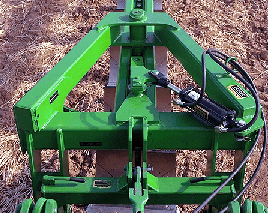 Integral in-furrow hitch
Integral in-furrow hitch
Compatible with tractors equipped with Quik-Coupler, the integral hitch offers unexcelled maneuverability in turns and when parking in tight areas:
- Tractor rockshaft lever controls the raising and lowering of the plow
- Maximum plowing depth is 356 mm (14 in.)
Adjustable width of cut improves residue-handling ability
 Adjustable width of cut
Adjustable width of cut
The width of cut on all 975 Moldboard Plows can be set at 406 mm or 457 mm (16 in. or 18 in.) by moving the standards to different bolt holes in order to:
- Match the tractor horsepower to the soil conditions
- Improve the residue-handling ability
- Improve productivity
- Maximize fuel efficiency
The underframe clearance is 813 mm (32 in.) to allow excellent material flow through the plow.
Adjustable rear gauge wheel comes in standard equipment
 975 Moldboard Plow rear gauge wheel
975 Moldboard Plow rear gauge wheel
All 975 Moldboard Plows come with a rear gauge wheel included in standard equipment. The rear gauge wheel provides the following features:
- Controls the plowing depth of the rear of the plow in rolling terrain
- Stabilizes rear of the plow in soft soils
- Adjustable through a full range of plowing depths
- Designed for easy turnbuckle adjustment
- Equipped with 6.70-15 tire to eliminate bulldozing in soft soils
Features
Offers a variety of sizes and excellent residue flow
 610 Chisel Plow
610 Chisel Plow
The 610 Chisel Plow is available in a variety of sizes to help match tractor horsepower and work designs.
Model |
Width |
Type of fold |
Standards |
| Three-bar integral | 2.44 m to 6.10 m (8 ft to 20 ft) |
Non-fold | Rigid |
| TruPosition™ | |||
| Tru-Depth™ |
Typical percents of the residue cover that remains from the 610 are listed as follows (the percentages do not take into account variables such as the condition of the residue, speed, and soil type):
Starting residue cover (percent) |
Remaining non-fragile* residue cover (percent) |
Remaining fragile** residue cover (percent) |
||||||
|
with |
with |
with |
with |
with |
with |
with |
with |
100 |
80 |
70 |
60 |
60 |
55 |
50 |
45 |
45 |
90 |
72 |
65 |
55 |
55 |
50 |
45 |
40 |
40 |
80 |
65 |
56 |
50 |
50 |
45 |
40 |
35 |
35 |
70 |
55 |
50 |
42 |
42 |
38 |
35 |
30 |
30 |
60 |
50 |
42 |
35 |
35 |
33 |
30 |
27 |
27 |
50 |
40 |
35 |
30 |
30 |
27 |
25 |
22 |
22 |
40 |
32 |
28 |
25 |
25 |
22 |
20 |
18 |
18 |
*Non-fragile residue includes crops like corn, sorghum, wheat (more than 45 bu).
**Fragile residue includes crops like soybeans, edible beans, peas, wheat (under 45 bu), sunflower, peanuts, cotton.
Strong mainframe withstands demanding field conditions
 610 rigid frame
610 rigid frame
The 610 Chisel Plow features a large 102-mm x 102-mm (4-in. x 4-in.) tubular steel mainframe.
Welded construction adds the inner strength that withstands twisting and pulling through demanding field conditions.
Choice of rigid, TruPosition™, and Tru-Depth™ standards
 Rigid standard
Rigid standard
The rigid standard:
- Is in base equipment on three-section models
- Is 32 mm x 51 mm x 711 mm (1.25 in. x 2 in. x 28 in.)
- Design is suited for fields having few obstructions
- Will till to 203 mm (8 in.) deep
- Good clearance to handle heavy trash
- 711-mm (28-in.) underframe
- 305-mm (12-in.) spacing
 TruPosition standard
TruPosition standard
The TruPosition standard:
- Is optional on all models
- Cast pivot assembly holds shank firm while working in the soil
- Is 32 mm x 51 mm x 711 mm (1.25 in. x 2 in. x 28 in.)
- Shank is replaceable without disassembly of the standard assembly
- Trip action is suited for fields having rocks or other obstructions
- 550-lb trip 711-mm (28-in.) standard will till to 203 mm (8 in.) deep
- 711-mm (28-in.) underframe
- 305-mm (12-in.) spacing
- Trip height of 254 mm (10 in.) for good clearance
- Slotted lower hole to aid in removing ground-engaging tools
 Tru-Depth standard
Tru-Depth standard
The Tru-Depth standard:
- Is optional on drawn rigid and select drawn flexible models up to 838 mm (33 ft)
- Is 51 mm x 32 mm x 813 mm (2 in. x 1.25 in. x 32 in.); edge is bent for extra strength
- Designed to work in rocky ground and heavy draft conditions
- Will till to 305 mm (12 in.) deep
- Trip height of 279 mm (11 in.)
- 568-kg (1250-lb) trip force
- Excellent clearance to handle heavy trash
- 813-mm (32-in.) underframe
- 305-mm (12-in.) spacing
Implement warning lights enable safe transport
An implement warning light harness with a turn-signal module for two amber and two red lights are included as standard equipment for safe transport on roads.
The implement warning light harness requires one of the following:
-
Category 2, 3-point hitch with or without Quik-Coupler
- Category 3 and 3N, 3-point hitch with or without Quik-Coupler
Horsepower requirements
- The rigid and TruPosition™ standards require engine horsepower of 6 hp per ft to 10 hp per ft.
The Tru-Depth™ standard requires engine horsepower of 6 hp per ft to 14 hp per ft.
Operator's manual storage container comes as standard equipment
 Operator's manual storage container
Operator's manual storage container

A 102-mm (4-in.) diameter container provides storage to give the operator easy access to the manual at the front of the machine. It is made out of a durable polyethylene and will keep the manual clean and dry in all weather conditions.
The container was designed exclusively for John Deere and the John Deere logo is shown on the lid.
Three-bar coil-tine harrow attachment available to finish off the field
 Harrow
Harrow

A handy three-bar coil-tine harrow attachment fits compactly behind the chisel plow.
There is 305 mm (12 in.) of fore-aft clearance between the bars plus vertical clearance of 305 mm (12 in.).
-
NOTE:
Use the harrow attachment only on machines equipped with sweeps; do not use with the
Tru-Depth™ standard.
Features
Strong V-pattern frame promotes leading-edge shattering of center shank and material flow
 913 V-Ripper
913 V-Ripper

The frame design of the 913 V-Ripper positions the standards in a V pattern:
- Promotes leading-edge shattering of the center shank and material flow through the machine
The 127-mm x 178-mm (5-in. x 7-in.) cross-section frame has 10-mm (3/8-in.) thick walls:
- Provides strength to handle tractors of up to 150 power take-off (PTO) horsepower
- Same frame-size tubing as non-expandable 915 V-Ripper
- Parking stands are included in base equipment
Two-position integral hitch to meet operator requirements
 Low and high positions on 3-point mast
Low and high positions on 3-point mast

3-point hitch hookup is for Category 2 or 3N tractors.
The integral hitch can be set to two positions:
- 1 = Low position
Gives maximum transport clearance and allows ripping to approximately 508 mm (20 in.) deep with the 838-mm (33-in.) standards. - 2 = High position
Enables ripping to a maximum depth of 584 mm (23 in.) deep with the 838-mm (33-in.) standards.
Soil probe helps to determine proper operating depth
 Soil probe
Soil probe

The soil probe helps operators to determine the proper operating depth of their ripper points,
38 mm (1.5 in.) below the bottom of the compaction layer.
The probe allows obtaining the maximum amount of soil fracturing from the entire family of John Deere ripper points. Marked in 51-mm (2-in.) increments from 254 mm to 559 mm (10 in. to 22 in.), the probe provides accurate feedback of compaction layer depth.
It is stored on the mainframe of the ripper for convenient access. The operator's manual explains the proper use of the soil probe.
Features
19-mm (0.75-in.) straight shear-bolt standard minimizes soil and residue disturbance at the surface
 19-mm (0.75-in.) ripper standard
19-mm (0.75-in.) ripper standard

The 19-mm (0.75-in.) straight shear-bolt standard design moves through the soil minimizing soil and residue disturbance at the soil surface.
- Equipped with replaceable wear shins to control wear on the leading edge of the shank that greatly extends the life of the standard, unlike some of the competitive models
- Can only be equipped with 64-mm, 178-mm, or 254-mm (2.5-in., 7-in., or 10-in.) min-till ripper points
The 19-mm (0.75-in.) straight standard is base equipment. It is also available as an attachment for field conversion.
Variety of working widths available
The 2100 Minimum-Till Ripper is available in working widths from 2.29 m to 6.86 m
(7 ft, 6 in. to 22 ft, 6 in.).
Working width |
Number |
Spacing |
2.29 m (7 ft, 6 in.) |
3 |
762 mm (30 in.) |
2.74 m (9 ft) |
3 |
914 mm (36 in.) |
3.05 m (10 ft) |
4 |
762 mm (30 in.) |
3.81 m (12 ft, 6 in.) |
5 |
762 mm (30 in.) |
4.57 m (15 ft) |
5 |
914 mm (36 in.) |
5.33 m (17 ft, 6 in.) |
7 |
762 mm (30 in.) |
6.86 m (22 ft, 6 in.) |
9 |
762 mm (30 in.) |
6.86 m (22 ft, 6 in.) fold |
9 |
762 mm (30 in.) |
Heavy-duty frame handles tough operating conditions
 Frame on seven-standard model
Frame on seven-standard model

The frame is constructed with a 102-mm x 152-mm x 10-mm (4-in. x 6-in. x 0.375-in.) cross tube on three-, four-, five-, and seven-standard machines and 152-mm x 152-mm x 10-mm (6-in. x 6-in. x 0.375-in.) cross tube on nine-standard models where the hitch-mounting components are welded for maximum strength.
Truss tubes connect the cross tubes and are constructed with 127-mm x 127-mm x 13-mm (5-in. x 5-in. x 0.5-in.) steel tubing.
Welded together into one assembly, the frame is designed to handle the most severe operating conditions.
The mainframe is 4.06-m (160-in.) wide and is the same whether there are five shanks on 762-mm (30-in.) spacings. Frame extensions make this task possible and make configurations easier to adjust.
2100 Drawn Hitch option available for seven- and nine-standard models
 Nine-standard drawn hitch
Nine-standard drawn hitch

A drawn hitch option is available for those who want to use large row-crop tractors or 4WD tractors without a 3-point hitch.
The drawn hitch is only compatible with seven-standard and nine-standard 762-mm (30-in.) models. The drawn hitch is also available as an attachment for field conversion.
The transport wheels are placed in front of the front rank of the mainframe. This allows residue to flow freely and keeps the wheels close to the standards to allow the ripper to follow the ground contour.
The wheel modules are mounted to the front, rear, and end frame of the ripper, making it the most stable wheel package in the in-line ripper market. The tires are placed directly in front of the ripper standards so the shanks can remove the tire track in order to leave as level a profile as possible.
There is no need for stabilizer wheels with the drawn hitch. The wheels are located within 762-mm (30 in.) of the outside edge of the machine to provide stability in both field and transport conditions.
The nine-standard model has eight-bolt hubs and spindles with beefy 12.5L-15 tires. The seven-standard model uses 11L-15 tires. The large tires provide excellent field flotation and transport stability.
A pressure-compensating flow divider is the heart of the depth control system. Temporary adjustments can be made while maintaining the ability to raise and lower evenly.
The machine does not need to be fully raised at the end of a pass to keep the cylinders in phase, and cylinder stops are used to set the overall operating depth.
NOTE: The drawn hitch attachment is only compatible with serial number 1300 or newer machines.
 Seven-standard drawn hitch folded
Seven-standard drawn hitch folded
Closing wheel available to minimize surface disturbance
 Closing wheel
Closing wheel

Closing wheels can be added to the rear of the 2100 Minimum-Till Ripper with 19-mm (0.75-in.) standards.
Closing wheels offer the following benefits:
- Minimize surface disturbance created by the standard
- Provide more adjustments to match farming practices and varying soil conditions than competitive models
- 114 kg (250 lb) of down pressure
- Mounted close to the shank, allowing a high trip clearance for operation through washouts, etc.
- Mounted with an L-bracket, allowing better soil and residue flow
Spring-cushion coulters enable more level soil profile
 Straight blade shown
Straight blade shown
Cushion coulters cut and size residue and pre-slice the soil to allow a more level soil profile:
- 559-mm x 5-mm (22-in. x 0.177-in.) straight blade is in base equipment and allows the least amount of soil and residue disturbance.
- 559-mm x 5-mm (22-in. x 0.177-in.) rippled blade is optional equipment for use when increased soil movement is desired.
Stabilizer wheels ensure straight travel and provide support
 Adjustable stabilizer wheels
Adjustable stabilizer wheels

Two adjustable 521-mm x 203-mm (20.5-in. x 8-in.) stabilizer wheels are included in base equipment to ensure straight travel and provide support on three-, four-, five-, and seven-standard sizes. The nine-standard size has four stabilizer wheels.
The stabilizer wheels are designed to stabilize the unit and are not intended to be used as depth gauge wheels. The weight of the unit must be carried on the tractor.
Additional stabilizer wheels and tires can be added if field conditions warrant more support.
Features
Internal basket scrapers
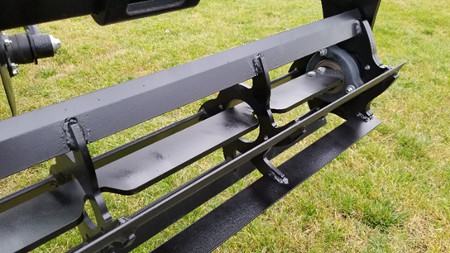 Internal basket scraper on knife-edge rolling basket
Internal basket scraper on knife-edge rolling basket
The internal basket scraper allows for a uniform field finish in wet conditions because the baskets will not need to be raised out of ground to avoid plugging and can stay in the ground 100 percent of the time.
This is available as an option for the knife-edge basket.
Variety of working and transport widths available to meet producer needs
The 2730 Combination Ripper is available in five machine configurations:
- 7S24 – 7-standard rigid frame with 610-mm (24-in.) spacing
- 9S24 – 9-standard rigid frame with 610-mm (24-in.) spacing
- 9S24 – 9-standard folding frame with 610-mm (24-in.) spacing
- 11S24 – 11-standard folding frame with 610-mm (24-in.) spacing
- 13S24 – 13-standard folding frame with 610-mm (24-in.) spacing
Model |
Working width |
Transport width |
Transport height |
7S24 Rigid – Individual blades |
4.27 m (14 ft) |
6.07 m (19 ft, 11 in.) |
2.49 m (8 ft, 2 in.) |
7S24 Rigid – Disk gangs |
4.27 m (14 ft) |
5.74 m (18 ft, 10 in.) |
2.49 m (8 ft, 2 in.) |
9S24 Rigid – Individual blades |
5.49 m (18 ft) |
6.86 m (22 ft, 6 in.) |
2.49 m (8 ft, 2 in.) |
9S24 Rigid – Disk gangs |
5.49 m (18 ft) |
6.86 m (22 ft, 6 in.) |
2.49 m (8 ft, 2 in.) |
9S24 Folding – Individual blades |
5.49 m (18 ft) |
5.82 m (19 ft, 1 in.) |
3.30 m (10 ft, 10 in.) |
9S24 Folding – Disk gangs |
5.49 m (18 ft) |
5.82 m (19 ft, 1 in.) |
3.35 m (11 ft, 0 in.) |
11S24 Folding – Individual blades |
6.71 m (22 ft) |
5.59 m (18 ft, 4 in.) |
3.81 m (12 ft, 6 in.) |
11S24 Folding – Disk gangs |
6.71 m (22 ft) |
5.69 m (18 ft, 8 in.) |
3.81 m (12 ft, 6 in.) |
13S24 Folding – Individual blades |
7.92 m (26 ft) |
5.59 m (18 ft, 4 in.) |
4.39 m (14 ft, 5 in.) |
13S24 Folding – Disk gangs |
7.92 m (26 ft) |
5.69 m (18 ft, 8 in.) |
4.19 m (13 ft, 9 in.) |
The 7.90-m (26-ft) 2730 delivers a 44 percent increase in productivity over the largest 5.50-m (18-ft) John Deere 2700 Mulch Ripper. The 2730 fits into a tillage system that includes the following secondary tillage tools:
- 2230 Field Cultivator
- 2330 Mulch Finisher
- 2630 Series Disks
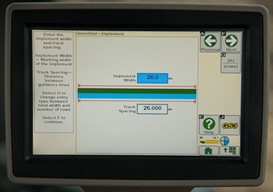 GreenStar™ display track spacing
GreenStar™ display track spacing
The ability to set the true width of the 2730 into the track spacing setting on the GreenStar display delivers a 6 percent increase in productivity allowing the operator to cover more acres in the same amount of time versus the competition. The true width is achieved through additional disk blades along with their tapered design to ensure consistent coverage and a level finish across the entire tillage pass.
Multifunctional implement for single-pass primary tillage
The 2730 is a combination ripper that integrates four operational areas into one system. These four areas consist of disk blades, ripper shanks, rear closing disks, and finishing attachments. The ability to quickly and conveniently customize these components independently offers reduced cost of operation and maximum productivity.
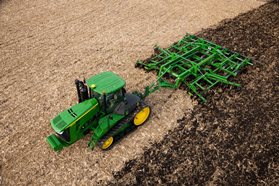 2730 operating in corn stalks
2730 operating in corn stalks
The disk blades eliminate the need for multiple residue sizing passes into one single pass that reduces surface residue levels by 60-80 percent. The 2730’s ability to mix and bury more residue leads to faster soil warming in the spring all while reducing negative impacts of disease and insect pressure.
The ripper shanks accomplish full hardpan fracture across the entire soil profile with their 610-mm (24-in.) spacing in order to create a porous air and water environment for root development. Along with the ripper shank’s side-to-side spacing, it also features a 1270-mm (50-in.) fore-aft spacing that improves residue disbursement and contributes to the machines nearly plug-proof performance.
With TruSet™ or manual adjustment, the operator can set this system to leave a uniformly mounded profile covering each ripper track, or it can be adjusted to obtain a smooth, level surface ideal for minimum preparation for the next spring’s seedbed. With the walking tandem action, the closing system can follow the contour of the ground and eliminate plugs leading to a more consistent finish.
To achieve optimal field levelness and clod sizing, the operator can control the finishing attachment with in-cab, hydraulic controls. The finishing attachments can be set to constant down pressure, float, or in wet field conditions, rise completely out of the ground. This will insure the seedbed is best prepared for the least amount of pre-plant seedbed tillage passes before planting.
Typical percentage of residue cover remaining from the 2730 Combination Ripper is listed in the table below. These percentages do not take into account variables such as the conditions of the residue, speed, and soil type.
NOTE: Percentages assume disk blades are operating at 152 mm (6 in.) of depth.
Starting residue cover (percent) |
Remaining non-fragile* residue cover (percent) |
Remaining fragile** residue cover (percent) |
||
57-mm (2.25-in.) point |
178-mm (7-in.) point |
57-mm (2.25-in.) point |
178-mm (7-in.) point |
|
100 |
30 |
27 |
15 |
12 |
90 |
27 |
25 |
14 |
11 |
80 |
24 |
22 |
12 |
10 |
70 |
21 |
19 |
11 |
8 |
60 |
18 |
16 |
9 |
7 |
50 |
15 |
14 |
8 |
6 |
40 |
12 |
11 |
6 |
5 |
*Non-fragile residue includes crops like corn, sorghum, and wheat (more than 1586 L [45 bu]).
**Fragile residue includes crops: soybeans, edible beans, peas, wheat (less than 1586 L [45 bu]), sunflower, peanuts, and cotton.
TruSet™ provides precise depth and pressure control from the cab on the go
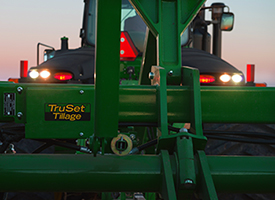 TruSet on the 2730 Combination Ripper
TruSet on the 2730 Combination Ripper
 TruSet run page
TruSet run page
In just six seconds, 2730 Combination Ripper operators can manage their changing field conditions by making on-the-go adjustments for the entire implement from the tractor cab. TruSet enables users to adjust depths for the disks, rippers, and closing disks, and adjust the pressure on the active hydraulic rolling baskets – all while covering acres.
As conditions change throughout the field, operators running the 2730 with TruSet can quickly and efficiently respond to varying soils, compacted areas, heavier residue, and moisture. Making customized adjustments that respond to these agronomic factors help customers maximize their yield potential.
Adjusting the 2730 Combination Ripper with TruSet can be done up to 200 times faster than the manual adjustment process using single-point depth control and cylinder stops. With short windows to perform tillage work, that critical time savings could be the difference in getting fields worked or not.
Operators no longer have to sacrifice machine performance by deciding to forgo manual adjustments throughout the field. At the touch of a button, TruSet users can quickly respond to changing conditions such as running deeper over end rows or shallower on hilltops and lighter soils. TruSet users can optimize their 2730 depth adjustments to maximize tractor performance for more efficient fuel use, and lower overall operating costs.
TruSet also add precision to tillage operations. The system offers depth accuracy of 2.5 mm (0.1 in.) and more than doubles the number of depth setting increments on the 2730 Combination Ripper. This finite level of control enables 2730 operators to create the ideal soil structure, and evenly size and distribute residue for maximum yield potential.
| Functional area | 2730 adjustment settings without TruSet | 2730 adjustment settings with TruSet | Improvement |
| Front disks | 32 | 80 | 150 percent |
| Rippers | 47 | 95 | 100 percent |
| Closing disks | 20 | 50 | 150 percent |
Single-point depth control is standard on all 2730 Combination Rippers. Single-point depth control provides the option for users to manually set implement depth, even with TruSet.
Functionality
This advanced tillage technology, available exclusively from John Deere, provides operators with real-time knowledge of the settings for each functional area on the implement. With a working tillage width of up to 7.9 m (26 ft) on the 2730, consistent tillage performance can be easily obtained from front to back across all four functional areas of this machine.
Both the set points entered by the user and the actual running depth or pressure for each area on the implement can be easily referenced for assurance of desired tillage outcomes. Once actual set point is validated and configured to the display in the cab, operators are able to make independent adjustments to the disks, rippers, or closing disks with accuracy within one tenth of an inch. Four memory set points enable operators to save different combinations of settings for their most common field conditions.
The independent adjustability of each area on the 2730 helps ensure TruSet users are efficiently managing residue and creating the ideal soil structure. By responding to conditions as they change throughout the field, TruSet operators generate better-quality tillage performance with the first pass.
Compatibility
TruSet is compatible with John Deere and competitive tractors. The following chart identifies the components needed to operate TruSet on a 2730 Combination Ripper with a GreenStar™ system-ready tractor.
|
John Deere 30 Series |
John Deere 20 Series |
Competitive tractors |
Yes |
Yes |
Yes |
|
No |
Yes |
Yes |
Like the TruSet Tillage System, the compatibility kit will be available as a field-installed option that can be ordered with the 2730 or through aftermarket parts. The compatibility kit includes an implement add-on valve and installation components.
All model years of the 2730 can be retrofitted with TruSet.
Additional information
Compatibility kit enables TruSet™ on competitive tractors and older John Deere tractors
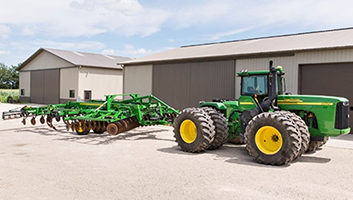 TruSet on 20 Series Tractor
TruSet on 20 Series Tractor
 Add-on Selective-Control Valve (SCV)
Add-on Selective-Control Valve (SCV)
Adding the TruSet compatibily kit to the TruSet Tillage system enables operators of competitive tractors and older John Deere tractors to adjust their depth and pressure settings on the go from the cab.
With the TruSet compatibility kit, TruSet can be run on the following GreenStar™ system-ready tractors:
- John Deere 20 Series Tractors and older
- Competitive tractors
Like the TruSet Tillage system, the compatibility kit will be available as a field-installed option that can be ordered with the 2730 Combination Ripper or through aftermarket parts. The compatibility kit includes an implement add-on valve and installation components.
All model years of 2730 can be retrofitted with TruSet. The following chart identifies the components needed to equip TruSet on a 2730 with a GreenStar ready tractor.
| TruSet product | John Deere 30 Series Tractors and newer |
John Deere 20 Series Tractors and older |
Competitive tractors |
| TruSet Tillage System | Yes | Yes | Yes |
| TruSet compatibility kit | No | Yes | Yes |
| Option code | Attachment | Description |
| 9407 | BKK10342 | TruSet compatibility kit for 2730 Combination Ripper |
Hydraulically adjustable 660-mm (26-in.) disk blades
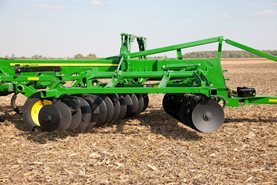 Hydraulically-adjustable disk blades
Hydraulically-adjustable disk blades
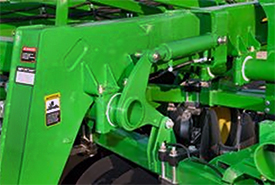 Hydraulic adjustment cylinder
Hydraulic adjustment cylinder
The 2730's large 660-mm (26-in.) disk blades are hydraulically adjustable and are set in a tandem-type configuration. The disks are available in either individual disk blades or gang-type configuration. The front and rear blades are set at an 18-degree angle on either 460-mm (18-in.) spacing for individual or 280-mm (11-in.) spacing for gang to provide an aggressive disking action.
The disks can be adjusted in-cab to be raised completely out of the ground or lowered to a maximum in-ground depth of 203 mm (8 in.). The disk blades operate in constant down-pressure and the optimal operating depth can be set from the cab with TruSet™ or manually using stop collars on the hydraulic cylinder. The ability to independently adjust the front disks based on varying conditions allows the operator to optimize desired residue sizing and mixing.
The larger disks are designed of high-quality steel and made from a manufacturing process for extended performance provide the following benefits:
- Size and bury residue
- Level the soil profile
- Mix the surface residue
- Give full-width tillage up to 200 mm (8 in.) deep
Walk-Over tandem wheels offer maximum support, stability, and flotation
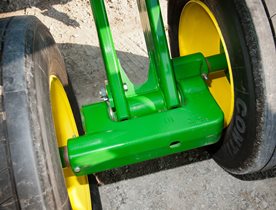 Walk-Over tandem wheels
Walk-Over tandem wheels
Walk-Over tandem wheels with larger tire options offer maximum support, stability, and flotation in the field. The staggered wheel design provides additional room for residue flow and obstacles all while providing a consistent working depth in uneven ground.
The Walk-Over tandem mainframe wheels come equipped with 57-mm (2.25-in.) plug-in spindles and eight-bolt hubs on the 7- and 9-standard models, and 79-mm (3.125-in.) plug-in spindles and ten-bolt hubs on the 11- and 13-standard models. The 11- and 13-standard models feature an active-hydraulic wing wheel to ensure a consistent operating depth with uniform leveling. These active-hydraulic wing wheels allow the 2730 machine to better follow the contour of the land versus rigid-mounted wing wheels on competitive models.
Available tires options are listed below:
Model |
Mainframe tire |
Wing frame tire |
7-Standard 4.30 m |
12.5L-15 FI F LR* |
--- |
9-Standard 5.50 m |
340/65R18 Goodyear* |
--- |
9-Standard 5.50 m |
340/65R18 Goodyear* |
--- |
11-Standard 6.70 m |
550/45R22.5 Alliance* |
12.5L-15 FI F LR Goodyear* |
13-Standard 7.90 m |
550/45R22.5 Alliance* |
12.5L-15 FI F LR Goodyear* |
*Base tire option
With the option to upgrade to the market’s largest 10-bolt hub, heavy-duty 445/50R22.5 or high-flotation 550/45R22.5 tires on all models, the weight of the machine is evenly transferred to the ground to ensure stable transport and operation. All mainframe tires available produce maximum flotation and durability for in-field performance with 33 percent more tire-to-ground engagement than the competition.
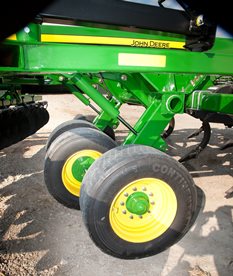 Wheels located in-between ripper shanks
Wheels located in-between ripper shanks
Goodyear is a trademark of The Goodyear Tire & Rubber Company.
Fore-aft ripper shank spacing delivers improved residue flow
 2730 Ripper Shanks buried in ground
2730 Ripper Shanks buried in ground

The 2730 delivers improved residue flow by increasing the overall frame length and underframe clearance along with the fore-aft spacing of the ripper shanks.
The 1270-mm (50-in.) fore-aft spacing maximizes residue disbursement and 953 mm (37.5 in.) of underframe clearance contribute to the machines nearly plug-proof performance. The 2730 features 610-mm (24-in.) side-to-side spacing that accomplishes full hardpan fracture across the entire soil profile to create a porous air and water environment for root development and plant nutrient uptake.
 Overhead view of 7-standard layout
Overhead view of 7-standard layout

For added durability and increased soil penetration, the 2730 boasts the largest and heaviest frame in the industry. The overall weight of each model ensures consistent machine performance. In high residue areas, 953 mm (37.5 in.) of underframe clearance results in reduced plugging and increased residue flow to maintain productivity and uptime.
Model |
Weight* |
7S24 Rigid – Individual blades |
7167 kg (15,800 lb) |
7S24 Rigid – Disk gangs |
7756 kg (17,100 lb) |
9S24 Rigid – Individual blades |
9072 kg (20,000 lb) |
9S24 Rigid – Disk gangs |
10,070 kg (22,000 lb) |
9S24 Folding – Individual blades |
9435 kg (20,800 lb) |
9S24 Folding – Disk gangs |
10,433 kg (23,000 lb) |
11S24 Folding – Individual blades |
13,608 kg (30,000 lb) |
11S24 Folding – Disk gangs |
14,696 kg (32,400 lb) |
13S24 Folding – Individual blades |
14,288 kg (31,500 lb) |
13S24 Folding – Disk gangs |
15,558 kg (34,300 lb) |
*Weights listed are for models equipped with no leveling attachment
Maintenance-free components reduce downtime
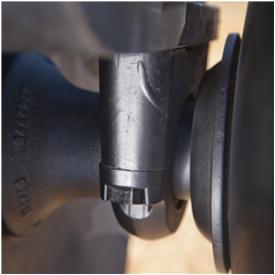 Sealed, maintenance-free bearing
Sealed, maintenance-free bearing
 Maintenance-free polymer bushing
Maintenance-free polymer bushing
Sealed, maintenance-free bearings on the 2730 Combination Ripper results in reduced downtime for the operator.
The greaseless bearings increase productivity by reducing the amount of time needed to service the 2730 before operation and allowing operators to spend more of their valuable time in the field. Independent testing results show the 2730 bearings have 30 percent less contamination than the competition. The maintenance-free bearings have been extensively field tested to stand up in tough conditions providing longer bearing life.
The 2730 employs a high-density polymer liner that allows the bearings to dynamically align the shaft in rough field conditions. The cast-bearing housing also allows for additional protection with the bearing wear guard built-in which leads to increased reliability.
The 2730 features 78 percent fewer grease points than major competitors resulting in less, time-extensive maintenance and improving field productivity by up to 3 ha (7.5 acres) per day.
Achieve desired field finish with hydraulically adjustable finishing attachments
 Hydraulic knife-edge rolling basket
Hydraulic knife-edge rolling basket
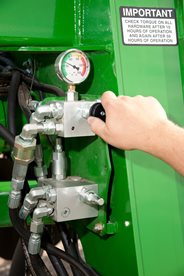 Active hydraulic pressure adjustment
Active hydraulic pressure adjustment
The 2730 comes equipped with the optional hydraulically adjustable finishing attachments to achieve the desired field finish. The hydraulic rolling baskets can be set to three hydraulically controlled positions from the comfort of the cab. The heavy-duty coil tine harrow is rigid mounted to the frame and depth adjustments are made according to the rear closing disk system. Based on field finish needs, the 2730 less harrow option is also available.
The finishing attachments come in a round-bar, knife-edge, or coil tine configuration and prepares field for a reduced amount of secondary tillage passes before planting. Below are the benefits of each attachment:
- Knife edge – better option in heavier, wet soils. Recommended basket for rocky soil types.
- Round-bar – best in dry conditions for clod sizing and firming. Slightly more prone to plugging over the knife edge.
- Heavy-duty coil tine harrow – preferred finishing attachment in heavy, poorly drained soils.
The rolling baskets can be hydraulically set to three different operating positions based on field conditions:
- Down pressure – a gauge on the front of the 2730 allows operators to set basket down pressure to ensure constant ground contact. Down pressure also allows for better sizing of slabs, clods, and root balls and will leave a level soil profile.
- Float – the baskets can be put in the float position using the selective control valve (SCV) on the tractor. This allows the weight of the basket to roll over the ground.
- Raised – the baskets can be lifted off the ground when encountering a wet area of the field to help eliminate any chance of plugging.
The active hydraulic down-pressure system allows the operator to increase the down pressure on finishing attachments up to 8274 kPa (1200 psi). Adjustments are made with a dial located next to the gauge. Down pressure should be set using the gauge and operated from the cab.
GoTill mobile application helps with implement setup and operation
The GoTill mobile application from John Deere is available on Apple® and Android™ smartphones. This application is a user-friendly system for operators to work their way through the initial recommended 2730 machine setup in order to optimize machine performance.
GoTill features a maintenance section and a notes section with photo functionality to give operators a premium experience when setting their machines. GoTill is also a great guide to use for settings and adjustments as field conditions differ to document changes made throughout the tillage season.
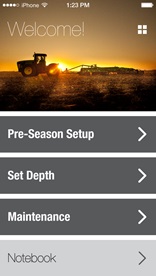
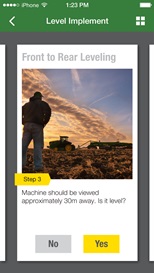
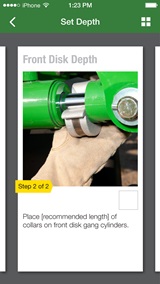
GoTill mobile screenshots |
GoTill is an impactful resource that can be used in addition to the operator’s manual settings guide that comes standard with all John Deere tillage equipment. GoTill is available on Apple App Store® and through Google Play™.
Android and Google Play are trademarks of Google LLC. Apple and Apple App Store are trademarks of Apple Inc.
Features
TruSet™ Tillage and single-point depth control

All 2720 Disk Rippers come with TruSet Tillage and single-point depth control in base equipment, providing operators with the choice of in-cab control or making manual adjustments.
TruSet Tillage depth and pressure control
In just six seconds, 2720 Disk Ripper operators can manage their changing field conditions such as running deeper over end rows or shallower on hilltops and lighter soils by making on-the-go adjustments for the entire implement from the tractor cab. TruSet enables users to adjust depth for the rippers and adjust the pressure on the active hydraulic rolling baskets – all while covering acres.
For the 2720, producers can also upgrade to TruSet active hydraulic stabilizer wheels to make in-cab adjustments for depth.
TruSet Tillage active hydraulic stabilizer wheels
Getting the field best performance just got easier with TruSet hydraulic stabilizer wheels. Choose TruSet hydraulic stabilizer wheels as an option on the 6.86-m (22.5-ft) nine-standard or 8.38-m (27.5-ft) 11-standard. The mechanical stabilizer wheels can be manually adjusted with a turnbuckle. TruSet enables operators to control the TruSet hydraulic stabilizer wheels from the cab while on the go. Requires TruSet depth and pressure control.
Functionality by depth-control option
| Single point | TruSet | |
| One adjustment to change implement depth | Yes | Yes |
| Mechanical adjustment option | Yes | Yes |
| In-cab adjustment option | No | Yes |
| Tillage documentation and prescription | No | Yes |
Single-point depth control is easily accessible from the front of the machine. This convenient performance feature:
- Is in base equipment
- Is ease to use
- Conveniently provides an infinite range of depth settings
- Gives excellent repeatability
TruSet Tillage provides precise depth and pressure control from the cab on the go
TruSet Tillage provides precise depth and pressure control from the cab on the go. Integrated TruSet Tillage technology enables disk ripper operators to adjust depth and down pressure on the active hydraulic rolling baskets while on the go to respond to changing field conditions such as varying soils, compaction, and moisture.
With a short window of time to perform tillage operations, TruSet can provide significant productivity improvements as operators are able to adjust the combination ripper while covering acres with the push of a button. By responding to conditions as they change throughout the field, TruSet enables operators to generate better-quality tillage performance with the first pass.
Using a GreenStar™ display, an operator sees real-time data for depth and basket down pressure for assurance of desired tillage outcomes. Once the actual set point is validated and configured to the display in the cab, operators are able to make independent adjustments as small as 2.54 mm (0.1 in.). Four customizable presets enable operators to save and name different combinations of settings for their most common field conditions.
Single-point depth control is included with the TruSet Tillage system, giving operators the choice of automated or manual adjustments. Hydraulic routings on the 2720 Disk Ripper are designed to allow each implement to feature both TruSet and standard single-point depth control for system redundancy, operator preference, and flexibility at resale.
Internal basket scrapers
 Internal basket scraper on knife-edge rolling basket
Internal basket scraper on knife-edge rolling basket
The internal basket scraper allows for a uniform field finish in wet conditions because the baskets will not need to be raised out of ground to avoid plugging and can stay in the ground 100 percent of the time.
This is available as an option for the knife-edge basket.
Typical percentages of residue cover remaining
Residue remaining
 2720 Ripper remaining residue in corn stalks
2720 Ripper remaining residue in corn stalks

Typical percentages of residue cover remaining from the 2720 Combination Ripper are listed in the table. These percentages do not take into account variables such as the conditions of the residue, speed, and soil type.
NOTE: Percentages assume disk gangs are operating at 152 mm (6 in.) of depth.
Starting |
Remaining non-fragile* |
Remaining fragile** |
||
57 mm (2.25 in.) |
178 mm (7 in.) |
57 mm (2.25 in.) |
178 mm (7 in.) |
|
100 |
40 |
35 |
15 |
12 |
90 |
36 |
32 |
14 |
11 |
80 |
32 |
28 |
12 |
10 |
70 |
28 |
25 |
11 |
8 |
60 |
24 |
21 |
9 |
7 |
50 |
20 |
18 |
8 |
6 |
40 |
16 |
14 |
6 |
5 |
The 2720 Ripper offers increased weight per blade over the 512 Ripper to penetrate rock-hard soils and deliver up to 203.2 mm (8 in.) of blade working depth to bury residue. The chart below details the weight per blade of the 2720 with and without a basket versus the 512.
Model/Size |
Five standards |
Seven standards (folding) |
Seven standards (non-folding) |
Nine standards |
11 standards |
512 Ripper |
288 |
272 |
279 |
333 |
Not applicable |
2720 Ripper without baskets |
359 |
372 |
345 |
439 |
421 |
2720 Ripper with baskets |
392 |
Not applicable |
410 |
474 |
456 |
The 2720 Ripper achieves increased weight per blade over the 512 because of the following:
-
Mainframe fore/aft tubes increased from 152.4x152.4 mm (6x6 in.) on the 512 to
177.8x177.8 mm (7x7 in.) on the 2720 -
Mainframe fore/aft tubes increased from 9.5-mm (0.38-in.) thick on the 512 to 12.7-mm (0.5-in.) thick on the 2720
-
Wing frames have changed from 6.4-mm (0.25-in.) thick on the 512 to 9.5-mm (0.38-in.) thick on the 2720
-
Increase in gang bolt size
-
Cast spools
 2720 Ripper burying corn residue
2720 Ripper burying corn residue

*Non-fragile residue includes crops like corn, sorghum, and wheat (more than 1585.8 L [45 bu]).
**Fragile residue includes crops: like soybeans, edible beans, peas, wheat (less than 1585.8 L [45 bu]), sunflower, peanuts, and cotton.
Walk-Over tandem wheels provide added support and stability
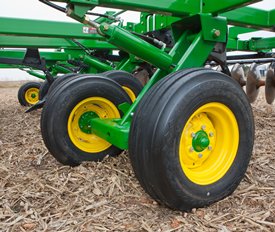 Tandem wheels
Tandem wheels
| 2720 Disk Ripper configuration | Tire option codes | Base or optional | Tire option description | Option codes for finishing components | Description of finishing components |
| 3.8 m (12.5 ft) five standards 28 disk blades |
4510 | In base price | Walk-Over tandem wheels, 57.2-mm (2.25-in.) diameter plug-in spindles and six bolt hubs - four 11L-15 FI D LR tires | --- | --- |
| 4512 | Optional | Walk-Over tandem wheels, 57.2-mm (2.25-in.) diameter plug-in spindles and six bolt hubs - four 11L-15 FI F LR tires | 6040 | Round-bar rolling basket | |
| 6041 | Knife-edge rolling basket | ||||
| 4518 | Optional | Walk-Over tandem wheels, 57.2-mm (2.25-in.) diameter plug-in spindles and eight bolt hubs - four 340/65R18 Goodyear® tires | 6040 | Round-bar rolling basket | |
| 6041 | Knife-edge rolling basket | ||||
5.4 m (17.5 ft) |
4512 | In base price | Walk-Over tandem wheels, 57.2-mm (2.25-in.) diameter plug-in spindles and six bolt hubs - four 11L-15 FI F LR tires | 6040 | Round-bar rolling basket |
| 6041 | Knife-edge rolling basket | ||||
| 4518 | Optional | Walk-Over tandem wheels, 57.2-mm (2.25-in.) diameter plug-in spindles and eight bolt hubs - four 340/65R18 Goodyear tires | 6040 | Round-bar rolling basket | |
| 6041 | Knife-edge rolling basket | ||||
6.9 m (22.5 ft) |
4518 | In base price | Walk-Over tandem wheels, 57.2-mm (2.25-in.) diameter plug-in spindles and eight bolt hubs - four 340/65R18 Goodyear tires | 6040 | Round-bar rolling basket |
| 6041 | Knife-edge rolling basket | ||||
| 4520 | Optional | Walk-Over tandem wheels, 57.2-mm (2.25-in.) diameter plug-in spindles and eight bolt hubs - four 340/65R18 Michelin® tires | 6040 | Round-bar rolling basket | |
| 6041 | Knife-edge rolling basket | ||||
| 8.4 m (27.5 ft) 11 Standards 66 disk blades |
4518 | In base price | Walk-Over tandem wheels, 57.2-mm (2.25-in.) diameter plug-in spindles and eight bolt hubs - four 340/65R18 Goodyear tires | --- | --- |
| 4520 | Optional | Walk-Over tandem wheels, 57.2-mm (2.25-in.) diameter plug-in spindles and eight bolt hubs - four 340/65R18 Michelin tires | 6040 | Round-bar rolling basket | |
| 6041 | Knife-edge rolling basket |
NOTE: The option code 6095 is included in the base price of the ripper. Option 6095 is listed under the finishing components and is less round rolling basket.
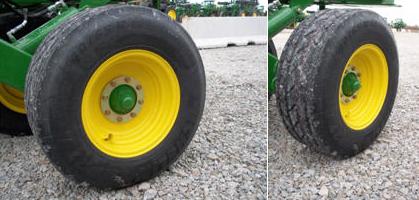 Michelin 340/65R18 tires
Michelin 340/65R18 tires
Walk-Over tandem wheels provide added support and stability for smoother operation in the field.
 Wheels in front of ripper shanks
Wheels in front of ripper shanks
The wheels are located behind the front disk gangs and in front of the ripper shanks. This allows the wheels to run on ground that has been leveled by the front disk gangs for more stable operation.
Goodyear is a trademark of Goodyear Rubber and Tire Company. Michelin is a trademark of Michelin North America, Inc.
Level-lift hitch/turnbuckle holds the frame level
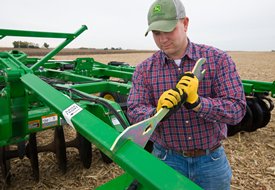 2720 level-lift hitch
2720 level-lift hitch

The level-lift hitch/turnbuckle:
- Holds the frame level fore and aft for consistent depth throughout its range of operating depth, without the need to re-level the machine when the depth is changed
- Allows the operator to go from the working position to the transport position without re-leveling the machine
A single 152-mm x 254-mm (6-in. x 10-in.) hitch tube enables tighter turns on the headlands without the inside tractor dual interfering with the hitch tube.
The turnbuckle is used to adjust fore-aft leveling:
- Convenient, easy adjustment to match the hitch to the tractor drawbar
- Locking mechanism makes it easy to adjust turnbuckle as required; no jam nut to tighten
- Adjustment is made only once for each tractor
The turnbuckle-adjustment wrench is in base equipment:
- Stores for easy accessibility
- Also used to adjust eye bolts for wing depth control cylinders
Ripper standards are located between the disk gangs
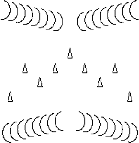 Disk and shank pattern
Disk and shank pattern

The 2720 Combination Ripper uses the disk-shank-disk configuration (DSD). In the DSD configuration, the ripper standards are located between the disk gangs instead of behind them (or DDS) as some competitors use.
With the shanks at the rear of the machine, the shanks can leave large ridges and valleys.
Disk gangs use field-proven gang components from the 2600 Series Disks
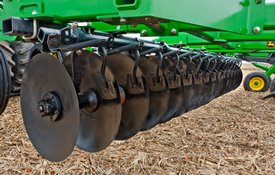 Disk gang spacing
Disk gang spacing
The 2720 Ripper disk gangs use field-proven gang components from the 2600 Series Disks for excellent reliability and performance. Disk gangs provide the following:
- Sizes residue to flow through spring tillage tools
- Kills weeds
- Works the soil
- Levels the soil profile
- Mixes the surface residue
- Gives full-width tillage up to 152-mm (6-in.) deep
C-spring standards protect the gangs from obstacles. Sealed, maintenance-free bearings prevent foreign material from getting into the bearings, thus ensuring long life. The bearings come with a two-year warranty.
The 2720 disk gang also features a floating scraper that is now mounted to the gang instead of to the gang tube. This allows the scraper to stay in constant contact with the blade when the gang side-loads in harsh conditions, allowing for increased residue flowing capability.
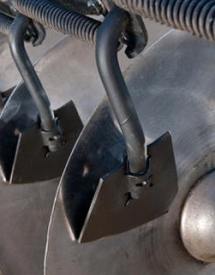 Floating scrapers mounted to the gang to increase residue flow
Floating scrapers mounted to the gang to increase residue flow
The 610-mm x 6.5-mm (24-in. x 0.256-in.) solid spherical low-concavity disk blades are spaced at 279 mm (11 in.) for sizing residue and to ensure residue flows well through spring tillage tools.
NOTE: Pieces are not sized so small they deteriorate quickly, blow away easily, or are buried readily, and yet are small enough to flow through a field cultivator.
Category 5 hitch link available
High draft requirements
Operators are requiring faster field working speeds and larger implements and tractors because of a dramatic increase in farm size. The market is asking for and receiving tractors with more torque, more weight, and more horsepower. This increased draft requires more from the implement frame and hitch components.
Frames and hitches have been redesigned with increases in frame tube thickness, additional diagonal bracing, and frame gussets for 447.4-kW (600-hp) engine requirements.
 Category 5 implement hitch link
Category 5 implement hitch link

As part of the redesign, implements include a heavy-duty Category 5 implement hitch link, providing the necessary strength and dimensions to match a Category 5 tractor drawbar and associated load.
The drawbar pin is increased from 51 mm (2 in.) with Category 4 to 70 mm (2.75 in.) with Category 5. The hitch link thickness is increased from 47 mm (1.85 in.) with Category 4 to 58 mm (2.28 in.) with Category 5.
The addition of this option will satisfy tractor Category 5 drawbar requirements.
Compatibility
-
Category 5 implement hitch links are not compatible with Category 4 tractor drawbars
-
Category 5 tractor drawbars are not compatible with Category 4 implement hitch links
-
Category 5 drawbars are currently not available on John Deere 9000 Series Tractors
Rolling baskets offer increased levelness
Round-bar or knife-edge rolling baskets
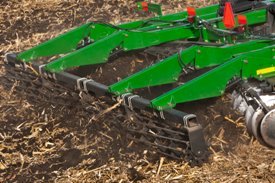 Hydraulic round-bar rolling basket
Hydraulic round-bar rolling basket
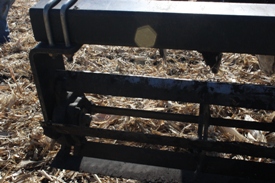 Hydraulic knife-edge rolling basket
Hydraulic knife-edge rolling basket
The industry-exclusive hydraulic rolling baskets found on the 2600 Series Disks and vertical tillage are also available on the 2720 Disk Ripper. The baskets come in a round-bar or knife-edge configuration.
Below are the benefits of each basket:
- Round bar – does a better job of busting clods and firming the ground. Slightly more prone to plugging over the knife edge because there are more bars. Works best in drier conditions.
- Knife edge – slices through clods. Works best in heavier, wet soils. Knives grab dirt and recycle more to size clods more effectively. Cleans out very well in the field.
The rolling baskets can be set in three different positions based on their hydraulic operation:
- Down pressure - a gauge on the front of the 2720 allows operators to set basket down pressure to ensure constant ground contact. Down pressure also allows for better sizing of slabs, clods, and rootballs and will leave a level soil profile.
- Float - the baskets can be put in the float position using the selective control valve (SCV) on the tractor. This allows the weight of the basket to roll over the ground.
- Raised - the baskets can be lifted off the ground when encountering a wet area of the field to help eliminate any chance of plugging.
Down pressure should always be set using the gauge and operated from the cab.
- Baskets are attached to the frame by a welded gusset, not straps and bolts. This makes the basket attaching method much more reliable to withstand harsh field conditions.
 Basket attachment to frame
Basket attachment to frame

NOTE: Rolling baskets are not available on the seven-standard rigid narrow transport model.
Contact a John Deere dealer for more information on Round-bar rolling baskets and Knife-edge rolling baskets.
Easily tension disk gang bolts
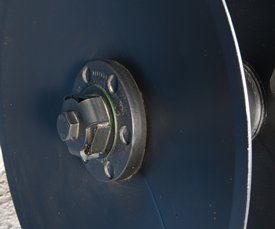 50-mm (2-in.) disk gang bolts
50-mm (2-in.) disk gang bolts
 Gang tension system
Gang tension system
John Deere's 2600 Series Disks provide an innovative approach to tension disk gang bolts.
Narrow-transport configurations available
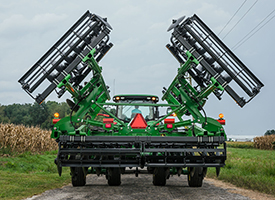 Rear view of folded 2720 Narrow Transport
Rear view of folded 2720 Narrow Transport
 Side view of folded 2720 Narrow Transport
Side view of folded 2720 Narrow Transport
The 2720 Disk Ripper provides multiple narrow-transport configurations that enable producers to easily maneuver their implements. The seven-standard 2720 is available in rigid and folding configurations.
Transport dimensions and rolling basket compatibility vary by tool. The folding seven-standard narrow-transport configuration is a true three-section machine with folding baskets.
| Seven-standard configurations | Rolling basket compatible | Transport width | Transport height |
| Rigid, narrow transport | No | 5.5 m (18 ft) | 2 m (6.6 ft) |
| Folding, narrow transport | Yes | 4.3 m (14 ft) | 4.1 m (13.5 ft) |
Features
Economical single parabolic standard ripper promotes root growth
A single parabolic standard ripper provides an economical means of shattering hardpan soil by exploding the soil upward to promote root growth:
- Curved standard is less likely to slice through marginally moist soils than a straight standard
- Mole ball can be attached to the standard to help drain wet soils by leaving a small tunnel under the soil
- V-knife can be attached to the standard to effectively cut the root systems
- Improves water percolation into the subsoil zone
Two sizes of standards are available:
- 25 mm x 686 mm (1 in. x 27 in.)
- Maximum working depth of 406 mm (16 in.)
- 32 mm x 838 mm (1.25 in. x 33 in.)
- Maximum working depth of 559 mm (22 in.)
Both standards are protected for up to 6364 kg (14,000 lb) of operating force by a 16-mm (5/8-in.) shear bolt.
Attaches to 3-point hitch
The 22B In-Line Ripper attaches to the tractor's 3-point hitch:
- 25-mm x 686-mm (1-in. x 27-in.) standard model is compatible with Category 1, 3-point hitch tractors.
- 32 mm x 838 mm (1.25 in. x 33-in.) standard model is compatible with Category 2 or 2/3N tractors with or without Quik-Coupler
- 16.9-30 or larger rear tractor tires are recommended
Features
Six sizes available to fit right machine to any size operation
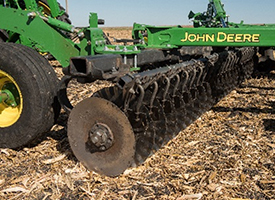 Ground-engaging components on 2633VT
Ground-engaging components on 2633VT
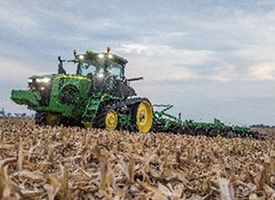 2633VT pulled by 8370RT
2633VT pulled by 8370RT
The John Deere 2633VT offers six different sizes to fit any size operation, big or small.
| Model | 2633VT |
| Purpose | Vertical tillage |
| Working depth | Up to 75 mm (3 in.) |
| Standards | C-spring |
| Gang angle | 21 degrees front 19 degrees rear |
| Front gang blades |
|
| Rear gang blades | 560 mm x 5 mm (22 in. x 0.197 in.) solid shallow concavity 13 wave |
| Blade spacing | 185 mm (7.25 in.) |
| Gang bolt | 50 mm (2 in.) |
| Horsepower | 27-36 hp/m (8.5-11 hp/ft) working width |
| Working widths | 6.3 m to 12.4 m (20 ft, 9 in. to 40 ft, 8 in.) |
| Operating speed | 11-16 km/h (7-10 mph) |
Size |
6.3 m |
8 m |
8.9 m |
9.3 m |
10.2 m |
12.4 m |
Weight |
6796 kg |
9060 kg |
9230 kg |
9920 kg |
10025 kg |
12991 kg |
Number of blades |
68 |
88 |
96 |
104 |
112 |
136 |
Weight per blade |
100 kg |
103 kg |
96 kg |
95 kg |
90 kg |
95 kg |
Horsepower requirement |
131.2-170 kW |
164.8-213.3 kW |
184.2-237.9 kW |
196.1-254.3 kW |
208.8-270.7 kW |
259.5-335.6 kW |
Transport height |
3.05 m |
3.90 m |
4.30 m |
4.21 m |
4.62 m |
3.75 m |
Transport width |
4.11 m |
4.11 m |
4.11 m |
4.77 m |
4.77 m |
4.95 m |
Unique blade configuration on 185-mm (7.25-in.) spacing optimizes one pass sizing and mixing
John Deere's 2633VT comes equipped on 185-mm (7.25-in.) spacing with solid shallow concavity spherical blades on the front gang and solid shallow concavity wavy blades on the rear gang to size residue and mix soil.
A majority of the sizing is going to be done by the front gang, and the rear gang is going to do the mixing. John Deere designed its vertical tillage tool to chop stalks to an acceptable size and begin soil mixing for breakdown, yet leave a considerable amount of residue on the cover.
The 2633VT comes equipped with 185-mm (7.25-in.) spacing on the front and rear gang. Both blade sizes on front and rear gang are 560 mm x 5 mm (22 in. x 0.197 in.). Optional 560-mm x 6.5-mm (22-in. x 0.256-in.) blades are available on front gang only.
Front solid shallow concavity spherical blade
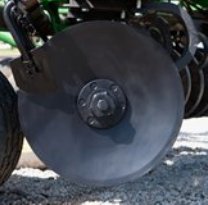 Solid shallow concavity spherical blade
Solid shallow concavity spherical blade
- Chops and sizes residue
- Manages weeds
- Manages root balls
- Removes field ruts
Rear solid shallow concavity wavy blade
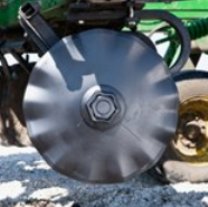 Solid shallow concavity wavy blade
Solid shallow concavity wavy blade
- Mix soil and residue
- Aerates soil
- Anchors residue
Front and rear 185-mm (7.25-in.) spacing
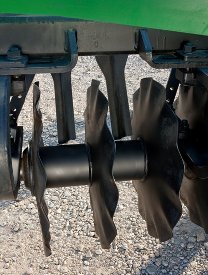 185-mm (7.25-in.) blade spacing
185-mm (7.25-in.) blade spacing

- Ideal for seedbed preparation
- Maximizes chemical incorporation
| Blade type | Solid spherical blade | Solid wavy blade |
| Thickness |
|
5 mm (0.197 in.) |
| Concavity | Shallow | Shallow |
| Diameter | 560 mm (22 in.) | 560 mm (22 in.) |
| Recommended soil types | All soil types | All soil types |
Easily tension gang bolts
 51-mm (2-in.) gang bolts
51-mm (2-in.) gang bolts
 Gang tension system
Gang tension system
John Deere's 2633VT Vertical Tillage tool provides an innovative approach to tension gang bolts.
Hydraulic fore-aft leveling enables operators to level machine from tractor cab
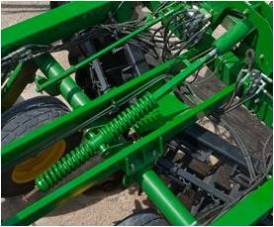 Hydraulic fore-aft leveling
Hydraulic fore-aft leveling
Hydraulic fore-aft leveling comes as standard equipment with John Deere's 2633VT Vertical Tillage tool. Operators can level the machine from the comfort of the tractor cab.
Versatile design of gang angle manages residue in fall and spring conditions
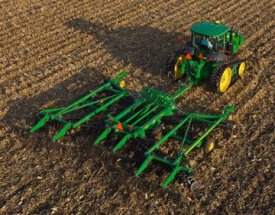 Residue management
Residue management
Whether the plan is to use the 2633VT in the spring or fall, this machine was designed to handle any residue management situation. With a 21-degree angle on the front gang and 19-degree gang angle on the rear gang, this tool was created to have aggressive sizing and chopping ability in tough residue in the fall and to have finishing characteristics to build an ideal seedbed in the spring.
 Shallow gang angle
Shallow gang angle
 Aggressive gang angle
Aggressive gang angle
Shallow gang angle vertical tillage tools can leave a wavy, washboard effect unsuitable for a proper seedbed. The 2633VT implement has an aggressive gang angle to help anchor residue, manage weeds and root balls, and create an even, smooth seedbed under the topsoil.
As crop yields increase, so does the amount of residue after harvest. The John Deere 2633VT allows producers to prepare soil for planting in the spring and residue management in the fall.
Utilize the residue calculator to identify the optimal residue management solution to meet the producer’s needs.
Active hydraulic rolling baskets create ideal seedbed
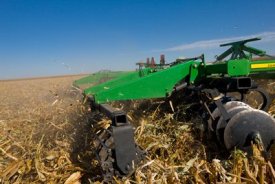 Hydraulic rolling basket with down pressure
Hydraulic rolling basket with down pressure
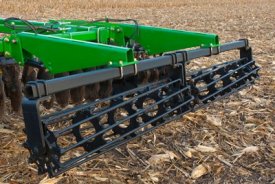 Hydraulic rolling basket - in raised position
Hydraulic rolling basket - in raised position
The 2633VT offers an active hydraulic rolling baskets that give the operator wide-ranging adjustability for a variety of conditions. The drawbars and rolling basket on the rear harrow are built with strength in mind for demanding vertical tillage conditions.
The system was designed to have the ability to run the rolling baskets in three different positions:
- Raised
- Allows the operator to raise the rolling baskets in harsh, muddy conditions
- Float
- Allows the operator to float the rolling baskets to lightly fluff soil
- Apply down pressure
- Allows the operator to adjust the basket pressure to provide consistent contact with the ground
- Provides a firm seedbed
- Shatters root balls
The hydraulic rolling basket is offered with a round bar, flat bar, or knife-edge. The flat bar is not recommended for rocky conditions. The knife-edge is best for heavier, wet soil.
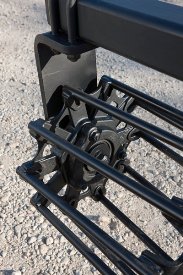 Maintenance-free bearing in rolling basket
Maintenance-free bearing in rolling basket
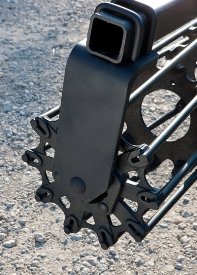 Maintenance-free bearing in rolling basket
Maintenance-free bearing in rolling basket
With these rolling baskets, a cast frame was designed to encase the bearing in a high-density polymer liner to allow dynamic movement and maintenance-free characteristics. Similar to the gangs on the 2633VT, the active hydraulic rolling baskets feature maintenance-free bearings to minimize non-productive activities.
 Hydraulic rolling basket down pressure valve
Hydraulic rolling basket down pressure valve
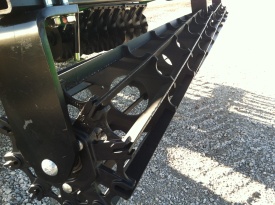 Hydraulic flat bar rolling basket harrow
Hydraulic flat bar rolling basket harrow
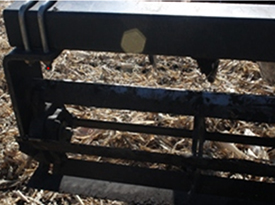 Hydraulic knife-edge rolling basket harrow
Hydraulic knife-edge rolling basket harrow
In order to change the rolling basket down pressure, simply rotate the down pressure valve dial clockwise to increase pressure and counterclockwise to decrease pressure.
Extended-life bearings improve productivity
John Deere’s 2630 Series Disks and Vertical Tillage Implements feature extended-life bearings. These more durable and reliable bearings allow producers to customize bearing maintenance for specific growing conditions and soil types.
The flange-mounted bearing and sealing system features improved contamination resistance. The advanced seal material is highly resistant to wear and damage caused by abrasive soils and other crop materials. The design of these are more durable and reliable than previous bearings.
The design of this bearing system allows for dynamic self-alignment to the gang bolt, as opposed to trunnion-mounted bearings that have limited alignment capability. This system features additional freedom of movement, accommodating a wider variety of field conditions. The bearing system has been designed to decrease stress and fatigue on the inner rolling surfaces, supporting extended bearing life.
The bearing and seal design allows for a limited, seasonal maintenance interval to minimize downtime. They also allow producers to customize the maintenance for specific growing conditions and soil types. The multi-lipped sealing system cannot be damaged by frequent greasing. It allows bearings to accept grease within the bearing as well as provide grease to the outer bearing surface to eliminate wear between the bearing and housing. With this design, the bearings can accept grease even if misaligned to the housing.
Multiple enhancements made to 2630 Series Disks
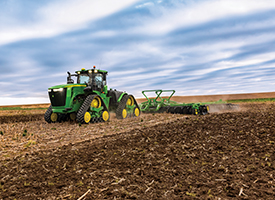
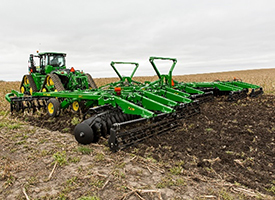
The 2630 Series Disks offer multiple upgrades and new items as options versus the 2620 Series Disks to enhance the machine. Check out the following video sharing more about the new 2630 Series Disks.
Extended-life bearings
John Deere’s 2630 Series Disks and Vertical Tillage Implements feature extended-life bearings. These more durable and reliable bearings allow producers to customize bearing maintenance for specific growing conditions and soil type.
TruSet™ side-to-side feature
John Deere TruSet system is featured in base equipment for the 2630 Series Disks and Vertical Tillage Implements. TruSet side-to-side is also available and features individual section leveling.
Knife-edge hydraulic rolling basket
The hydraulic rolling basket is now offered with a round bar, flat bar, or knife-edge. The knife-edge is best for heavier, wet soil, and can be used in rocky conditions.
Radial tires
The 2630 Series Disks and Vertical Tillage Implements feature radial tires for the mainframes in base equipment. Radial tires are available as an option on the wing frame and stabilizer wheels. These tires are designed to offer longer wear life and help minimize compaction with a wider plate and lower inflation pressures.
Stabilizer wheels
Producers can choose either mechanical stabilizer wheels or TruSet hydraulic stabilizer wheels as an option. Stabilizer wheels help to maintain a consistent, level depth and are recommended for operation on rolling ground. The mechanical stabilizer wheels can be manually adjusted with a turnbuckle. TruSet with side-to-side leveling capabilities also enables operators to control the TruSet hydraulic stabilizer wheels from the cab while on the go.
Features
Provides excellent residue handling
 Seedbed finisher in bean ground
Seedbed finisher in bean ground
 200 Seedbed Finisher with 2330 Mulch Finisher
200 Seedbed Finisher with 2330 Mulch Finisher
The 200 Seedbed Finisher has excellent residue-handling capability in secondary tillage.
The rolling baskets and spiraling rods separate soil from root balls and uprooted weed clumps, providing a level surface for planting.
The spiraling rods are spaced to produce a soil texture to thwart crusting, firm the soil, and preserve moisture in the seed zone for good seed germination and early root growth.
Each section of spiral rollers is spring cushioned to place firm pressure uniformly over uneven soil surface, facilitating good penetration and leveling.
Heavy-duty mainframe and wing frames provide added strength for improved leveling
 Truss tube wing frame
Truss tube wing frame
 200 Seedbed Finisher with 2330 Mulch Finisher
200 Seedbed Finisher with 2330 Mulch Finisher
Heavy-duty 102-mm x 102-mm (4-in. x 4-in.) double-truss tube construction on the 200 Seedbed Finisher's mainframe and wings provides added strength and down pressure for improved leveling and consistent rolling basket depth.
Dura-Flex™ (3+1) bearings offer a field-proven solution
 Dura-Flex bearings
Dura-Flex bearings
 200 Seedbed Finisher with 2330 Mulch Finisher
200 Seedbed Finisher with 2330 Mulch Finisher
The rolling baskets on the 200 Seedbed Finisher are secured with Dura-Flex bearings featuring the following:
- Elimination of gang bolt, spacers, washer
- Triple-lip seal arrangement
- Self-alignment
- Elimination of internal bearing stress
Simple tongue-length adjustment creates desired turning radius
 Telescoping tongue
Telescoping tongue
 Turning radius
Turning radius
Tongue-length adjustments can be made with a simple pin adjustment on the 200 Seedbed Finisher. This makes it easy to create the desired turning radius.
Wing weight package to allow more aggressive leveling
In most applications, the weight of the base machine works extremely well with good leveling. However, for more aggressive action and more uniform weight distribution on the wings, two weight packages are available:
- The 136.4-kg (300-lb) weight package consists of 12 laser cut plates, six bolted to each wing end.
- The 272.7-kg (600-lb) weight package consists of 24 laser cut plates, 12 bolted to each wing end.
Grease fitting guard to minimize maintenance
 Bearing grease fitting guard
Bearing grease fitting guard
Small stones may occasionally get trapped inside the rolling basket and damage the grease fitting. The attached guard utilizes the bearing flange bolts and wraps around the grease fitting to minimize damage. The guard is contoured to allow good access for lubrication.
Features
Wide range of working widths available to match acreage and horsepower requirements
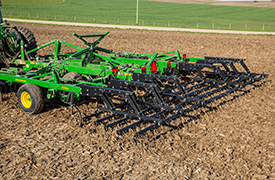 Three-section configuration
Three-section configuration
 Five-section configuration
Five-section configuration
At 16-km/h (10-mph) working speeds, the 2330 Mulch Finisher can cover up to 27.5 ha (68 acres) per hour enabling producers to size their implements for their unique productivity and agronomic needs.
The 2330 is available in sizes ranging from 6.6 to 17.2 m (21 ft, 9 in. to 56 ft, 3 in.). Horsepower requirements range from 24.5 to 34.2 kW/m (10 to 14 hp-ft), depending on the soil, depth, and speed.
Three-section configurations
| Working width | Centerframe size | Productivity per hour at 16 km/h (10 mph) |
| 6.63 m (21 ft, 9 in.) | 13.14 m (10 ft, 3 in.) | 10.5 ha (26 acres) |
| 7.54 m (24 ft, 9 in.) | 12.1 ha (30 acres) | |
| 8.46 m (27 ft, 9 in.) | 13.8 ha (34 acres) | |
| 9.37 m (30 ft, 9 in.) | 15.0 ha (37 acres) | |
| 10.29 m (33 ft, 9 in.) | 15.0 ha (37 acres) |
Five-section configurations
| Working width | Centerframe size | Productivity per hour at 16 km/h (10 mph) |
| 11.66 m (38 ft, 3 in.) | 13.14 m (10 ft, 3 in.) | 18.6 ha (46 acres) |
| 13.49 m (44 ft, 3 in.) | 21.9 ha (54 acres) | |
| 15.32 m (50 ft, 3 in.) | 24.7 ha (61 acres) | |
| 17.15 m (56 ft, 3 in.) | 27.5 ha (68 acres) |
NOTE: Specification and design subject to change without notice.
Level-Lift™ frame ensures even operation through all operating depths
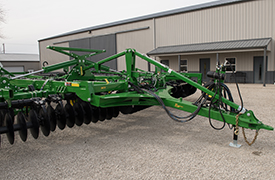 T-hitch with Level-Lift turnbuckle
T-hitch with Level-Lift turnbuckle
 Level-Lift turnbuckle
Level-Lift turnbuckle
The Level-Lift hitch ensures a level operation through all operating depths. It also provides consistent gang and sweep depth fore to aft for thorough seedbed preparation. This quick, easy adjustment ensures a flat seedbed floor and level soil profile for planting.
The combination of the disk gang, sweep, and harrow functions promotes consistent and uniform chemical placement and mixing. The T-hitch enables easy turnbuckle adjustment for fast tractor changeover and quick implement leveling fore to aft.
The heavy-duty T-hitch allows for tighter turning, decreasing the amount of headlands required for quick turns on the end. The T-hitch also houses the hoses and wiring harness, protecting them from crop and incidental tire contact.
Low-concavity disks are spaced for effective residue slicing
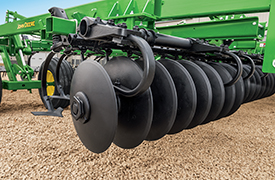 Low-concavity disk blades
Low-concavity disk blades
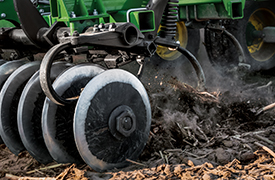 Disks engaged on 2330
Disks engaged on 2330
The producer can work ground faster with the 2330's 508-mm x 5-mm (20-in. x 0.197-in.) low-concavity disk blades and outside blades tapered to 457 mm (18 in.):
- Allows aggressive cutting action
- Minimizes ridging
Blades are spaced 184-mm (7.25-in.) apart and are fixed at an 8-degree gang angle:
- Results in effective slicing in heavy residue
- Moves the soil inward toward the center of the implement for a level seedbed
C-spring cushion gangs help protect against rocks and other obstructions in the field. Dura-Flex™ (3+1) bearings are standard equipment:
- Triple lip on the inner race and a wide seal between the outer race and flange prevents soil from entering between the bearings and flanges, and helps retain lubrication in the bearings
- Greaseable for long life
All disk gangs feature combination rigid/self-adjusting scrapers as standard equipment:
- Prevent soil buildup on inside of disk blades
- Adjustable to compensate for wear
- Self-adjusting operation—the spring tension helps hold the scrapers against the disk blade in sticky soil conditions
Engaged disk gangs add to the stability of the implement at higher ground speeds for consistent working depth in uneven ground.
- Allow for good weed kill and tilling
- Provide excellent chemical incorporation
True 229-mm (9-in.) split-the-middle spacing provides complete field coverage
 229-mm (9-in.) spacing
229-mm (9-in.) spacing
Thanks to an updated frame design that enables true 229-mm (9-in.) split-the-middle shank spacing, the 2330 Mulch Finishers can maintain consistent depth and evenly cover the field to achieve an optimal seedbed while flowing residue and managing weeds.
Seedbed preparation
Even at high speeds and in tough field conditions, the TruPosition C-shanks with 91 kg (200 lb) of trip force minimize side-to-side movement and provide the operator better control of the soil profile for improved leveling capabilities.
These shanks provide a full tillage cut across the entire width of the implement. The shanks stay firmly planted in tough soils without quickly relieving. As a result, the soil is mixed completely and streaks are reduced. This helps producers maximize their productivity and create flat seedbeds for smooth planter operation and consistent seed depth.
Weed management
The even 229-mm (9-in.) split-the-middle shank spacing enables the 2330 Mulch Finisher to minimize the potential of remaining strips of weeds that survive the tillage pass. With a mulch finisher pass just prior to planting/seeding, the crop can emerge into a weed-free field that gives it the best chance to reach canopy ahead of the weeds.
If some weeds emerge and a post-emergence herbicide is needed, weeds should be smaller and easier to control. As a result, the mulch finisher pass helps keep weed management costs under control and helps preserve crop yield potential.
TruPosition™ standards deliver 91 kg (200 lb) of trip force for consistent depth and even cut
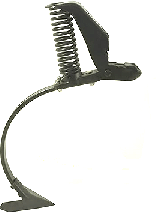 TruPosition standards
TruPosition standards
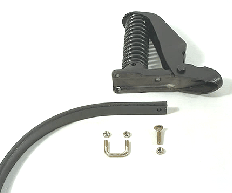 TruPosition standard components
TruPosition standard components
Producers are working ground at faster speeds and in tighter soil conditions, requiring more from standards and frames.
The 91-kg (200-lb) trip TruPosition standards include:
- Heat-treated mounting bracket
- Cast pivot assembly with front stop
- 19-mm x 45-mm x 610-mm (3/4 x 1-3/4 x 24-in.) C-shank, retained by a bolt through the casting and U-bolt—ensures consistent sweep depth, level seedbeds in all secondary conditions, and thoroughly incorporated chemicals
- 610-mm (24-in.) underframe clearance provides extra room for excellent residue flow on 229-mm (9-in.) spacing
- 254-mm (10-in.) trip height (at shank) clears rocks and obstacles
- Replaceable split-tension sleeve and chrome bushing extend life of standard and implement
These standards provide 91 kg (200 lb) of trip force and enable producers to maintain a consistent sweep depth. A combination of spring pressure and pivot casting geometry minimizes side-to-side movement and provides the ultimate in soil profile and seedbed.
Variety of 254-mm (10-in.) sweeps provide solutions for all soil conditions
Bolt-on and knock-on sweep options are available to customize the 2330 Mulch Finisher to perform well in a variety of field conditions.
| Bolt-on sweeps | Knock-on sweeps |
| Tru-Width™ sweeps | Perma-Loc™ sweeps |
| High-productivity sweeps | High-productivity Perma-Loc sweeps |
John Deere’s high-productivity sweep options are recommended for the high-working-speed market, and perform best at speeds of 11-16 km/h (7-10 mph). With a low profile and curved wing shape, the high-productivity sweeps provide low draft and consistent penetration while easily getting through tough and heavy residue. Compared to Tru-Width sweeps, high-productivity sweeps are designed to exert less draft and retain their shape for longer wear life so producers can stay productive in the field longer.
The high-productivity sweeps for the John Deere 2330 Mulch Finisher come in a 254-mm (10-in.) width, both in the bolt-on and the knock-on Perma-Loc version. They fit all 47-degree standards with 44-mm (1.75-in.) hole spacing and 11 mm (0.4375 in.) that currently take Tru-Width sweeps, both John Deere and other makes.
Bolt-on sweeps
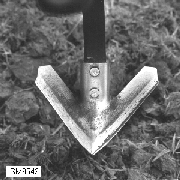 Tru-Width sweep
Tru-Width sweep
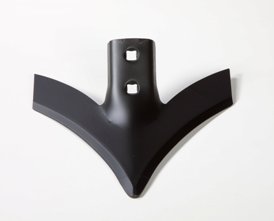 High-productivity sweep
High-productivity sweep
254-mm (10-in.) Tru-Width sweeps are optional on mulch finishers with 229-mm (9-in.) shank spacing.
The Tru-Width design offers the following benefits:
- Maintains full cutting width and point through the life of the sweep
- Gives greater wear life and improved performance over regular sweeps
- Provides superior scouring and penetration
- Works soil well for level seedbed and good seed-to-soil contact
- Gives excellent chemical incorporation
- Wears evenly and pulls easily
- Replacement without charge if breakage occurs before appreciable wear
Knock-on sweeps
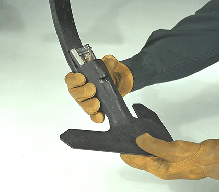 Perma-Loc sweep
Perma-Loc sweep
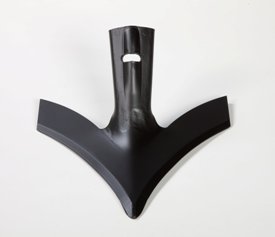 High-productivity Perma-Loc sweep
High-productivity Perma-Loc sweep
Perma-Loc utilizes a self-tightening ratcheting system for easy installation. Indentations formed in the sweep stem provide the spring clip with a locking surface. The adapter edge, sweep, and spring all act together to tightly lock the sweep to the shank. The operator simply pushes the sweep on by hand to the first notch (audible click). As the resistance is increased (ground engagement), the sweep progressively wedges tighter. The mounting design minimizes lost sweeps and wear on adapter.
Utilizing the removal tool to depress the spring through the stem access opening and a tap with a hammer easily releases the sweep from the adapter and spring.
Perma-Loc sweeps have the advantage of using a Tru-Width design for penetration, residue flow, and long life. The proven 47-degree sweep angle minimizes soil slabbing yet promotes soil movement. The narrow stem enhances excellent soil and residue flow. Stem geometry ensures soil flow over the spring access opening, effectively separating and lifting flow to a point higher on the shank. The force of soil flow is reduced on the shank, improving shank life.
The Perma-Loc system is standard equipment and consists of the following:
- Adapter
- Spring hardware
- Sweep
- Removal tool (separate option on field cultivators)
Tru-Width sweeps with the Perma-Loc adapter can seamlessly move the high-productivity sweeps.
The high-productivity sweeps uses the current Perma-Loc adapter for 47-degree curved standard, N237614.
ProFinish™ Leveling System offers wide range of rear harrows to meet agronomic needs

Depending on agronomic needs, producers have a choice of six rear harrow options included in the ProFinish Leveling System on the 2330 Mulch Finisher.
| Capabilities | 5-bar coil-tine harrow |
6-bar spike-tooth harrow |
3-bar coil-tine with round-bar basket |
3-bar coil-tine with flat-bar basket |
4-bar spike-tooth with round-bar basket |
4-bar spike-tooth with flat-bar basket |
| Level seedbed | Good | Better | Best | Best | Best | Best |
| Firm seedbed | Fair | Good | Best | Better | Best | Better |
| Handle residue | Best | Better | Best | Best | Better | Better |
| Break up clods | Good | Better | Better | Best | Better | Best |
| Handle moisture/wet soil | Best | Better | Good | Good | Good | Good |
| Handle rocks | Best | Good | Better | Good | Better | Good |
TruSet™ system provides precise depth and pressure control from the cab on the go
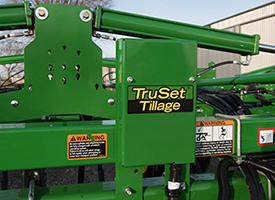 TruSet Tillage
TruSet Tillage
Integrated TruSet Tillage technology enables 2330 Mulch Finisher operators to adjust disk and sweep depth along with down pressure on the active-hydraulic rolling baskets.
With a short window of time to perform tillage operations, TruSet can provide significant productivity improvements as operators are able to adjust the mulch finisher while covering acres with the push of a button. By responding to conditions as they change throughout the field, TruSet enables operators to generate better-quality tillage performance with the first pass.
Using a GreenStar™ display, a user sees real-time data for disk and sweep depth, and basket down pressure for assurance of desired tillage outcomes. Once the actual set point is validated and configured to the display in the cab, operators are able to make independent adjustments as small as 2.5 mm (0.1 in.). Four customizable presets enable operators to save and name different combinations of settings for their most common field conditions.
Single-point depth control is included with the TruSet Tillage system, giving operators the choice of automated or manual adjustments. Hydraulic routings on the 2330 Mulch Finisher are designed to allow each implement to feature both TruSet and standard single-point depth control for system redundancy, operator preference, and flexibility at resale.
Components
TruSet is compatible with John Deere and competitive tractors. Depending on the tractor, a compatibility kit may be needed in addition to the TruSet Tillage system. The following chart identifies the components needed to operate TruSet on a 2330 Mulch Finisher with a GreenStar-ready tractor.
| TruSet product | John Deere 30 Series and newer tractors | John Deere 20 Series Tractors (large frame or IVT™ system) | John Deere 20 Series Tractors (small frame or non-IVT) |
John Deere 10 Series and older tractors | Competitive tractors |
| TruSet Tillage system | Yes | Yes | Yes | Yes | Yes |
| TruSet compatibility kit | No | No | Yes | Yes | Yes |
Both the TruSet Tillage system and the compatibility kit will be available as a field-installed option that can be ordered with the mulch finisher or through aftermarket parts.
All model years of the 2330 can be retrofitted with TruSet.
TruSet requires a GreenStar ready tractor with a supported display. The TruSet Tillage system must have a connection to the tractor ISO connection.
Additional TruSet information:
Tillage documentation and prescription functionality included with TruSet™ Tillage system
With integrated TruSet Tillage technology, 2330 Mulch Finisher operators can incorporate documentation and prescription functionality into their tillage operations. The tillage documentation feature will give producers the ability to capture and analyze the mulch finisher pass for additional coverage of the crop production cycle. Prescription functionality provides producers the capability to ensure their tillage operations are executed correctly, optimizing their investment in preparing for the next crop.
Operators can document data for the depth of their mulch finisher disks and sweeps along with rolling basket down pressure. By creating an as-applied map based off of global positioning system (GPS) data for the job performed by each functional area on the implement, TruSet enables producers to document their tillage pass then later review and analyze the data for future agronomic decisions.
Additionally, the Prescription Creator by Agrian® company, a connected partner tool through the John Deere Operations Center, enables producers to create prescriptions for each functional area on the 2330 Mulch Finisher. Data from previous yields, soil surveys, or freehand drawing tools can be used to create prescriptions that will command the implement to the desired depth and pressure settings for optimum agronomic results.
Agrian is a trademark of Agrian, Inc.
Rear hitch compatible with all 2330 configurations and rear harrows
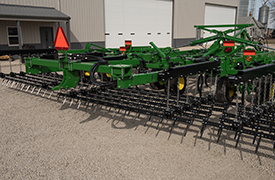 Rear hitch
Rear hitch
 2330 with 200 Seedbed Finisher
2330 with 200 Seedbed Finisher
A substantial rear hitch is available to give the 2330 the versatility to pull the 200 Seedbed Finisher or other tow-behind attachments. The rear hitch includes:
- Rectangular tube construction
- Telescoping hitch
- Serviceable drawbar
- 453-kg (1000-lb) tongue weight rating
- 13,000 gross vehicle weight (GVW) rating for five-section machines; 10,000 gross vehicle weight (GVW) rating for three-section machines
- Wiring harness for transport lights
- Hydraulic hoses and couplers
The rear hitch is fully compatible with all 2330 rear harrow configurations.
Features
Wide range of working widths available to match acreage and horsepower requirements
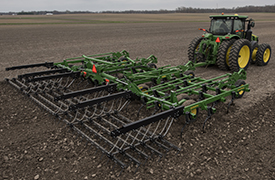 Three-section configuration
Three-section configuration
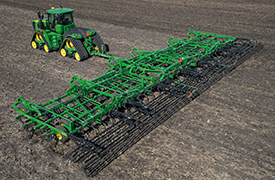 Five-section configuration
Five-section configuration
At 16-km/h (10-mph) working speeds, the 2230FH can cover up to 34 ha (84 acres) per hour, enabling producers to size their implement for their unique productivity and agronomic needs.
The 2230FH is available in sizes ranging from 7.8 to 21.2 m (25 ft, 6 in. to 69 ft, 9 in.). Horsepower requirements range from 19.6-29.4 kw/m (8 to 12 hp-ft), depending on the soil, depth, and speed.
Three-section configurations
| Working widths | Centerframe size | Productivity per hour at 16 km/h (10 mph) |
| 7.77 m (25 ft, 6 in.) | 3.4 m (11 ft) | 12.5 ha (31 acres) |
| 8.99 m (29 ft, 6 in.) | 14.6 ha (36 acres) | |
| 9.60 m (31 ft, 6 in.) | 15.4 ha (38 acres) | |
| 10.21 m (33 ft, 6 in.) | 16.6 ha (41 acres) | |
| 10.82 m (35 ft, 6 in.) | 17.4 ha (43 acres) | |
| 12.95 m (42 ft, 6 in.) low transport |
21.0 ha (52 acres) |
Five-section configurations
| Working widths | Centerframe size | Productivity per hour at 16 km/h (10 mph) |
| 12.34 m (40 ft, 6 in.) | 3.4 m (11 ft) | 19.8 ha (49 acres) |
| 13.56 m (44 ft, 6 in.) | 21.9 ha (54 acres) | |
| 14.78 m (48 ft, 6 in.) | 23.9 ha (59 acres) | |
| 16.00 m (52 ft, 6 in.) | 25.9 ha (64 acres) | |
| 17.22 m (56 ft, 6 in.) | 27.5 ha (68 acres) | |
| 18.44 m (60 ft, 6 in.) | 29.5 ha (73 acres) | |
| 18.44 m (60 ft, 6 in.) | 4.6 m (15 ft) | 29.5 ha (73 acres) |
| 19.66 m (64 ft, 6 in.) | 31.6 ha (78 acres) | |
| 21.18 m (69 ft, 6 in.) | 34.0 ha (84 acres) |
Floating hitch frame keeps implement level across varying terrain
 Floating hitch frame on 2230FH
Floating hitch frame on 2230FH
 Level-lift hitch frame on 2230LL
Level-lift hitch frame on 2230LL
The 2230FH Floating Hitch Field Cultivator offers superior ground-hugging capability with precise depth and pressure control across all types of terrain. The floating hitch frame design enables this field cultivator to work independently of the tractor and follow the contour of the ground so the implement remains level. The 2230FH commands consistent depth from front to back and from side to side.
True 152-mm (6-in.) split-the-middle spacing provides complete field coverage
 TruPosition™ standards on 2230 Field Cultivator
TruPosition™ standards on 2230 Field Cultivator
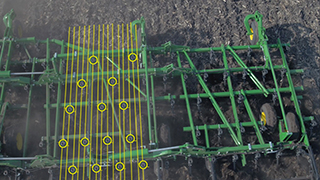 152-mm (6-in.) split-the-middle shank spacing
152-mm (6-in.) split-the-middle shank spacing
Thanks to an updated frame design that enables true 152-mm (6-in.) split-the-middle shank spacing, the 2230 Field Cultivators can maintain consistent depth and evenly cover the field to achieve an optimal seedbed and manage weeds.
Seedbed preparation
Even at high speeds and in tough field conditions, the TruPosition C-shanks with 91 kg (200 lb) of trip force minimize side-to-side movement and provide the operator better control of the soil profile for improved leveling capabilities.
These shanks provide a full tillage cut across the entire width of the implement. The shanks stay firmly planted in tough soils without quickly relieving. As a result, the soil is mixed completely and streaks are reduced. This helps producers maximize their productivity and create flat seedbeds for smooth planter operation and consistent seed depth.
Weed management
The even 152-mm (6-in.) split-the-middle shank spacing enables the 2230 Field Cultivator to minimize the potential of remaining strips of weeds that survive the tillage pass. With a field cultivator pass just prior to planting/seeding, the crop can emerge into a weed-free field that gives it the best chance to reach canopy ahead of the weeds.
If some weeds emerge and a post-emergence herbicide is needed, weeds should be smaller and easier to control. As a result, the field cultivator pass helps keep weed management costs under control and helps preserve crop yield potential.
Spacing options
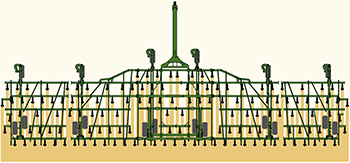 True 152-mm (6-in.) split-the-middle spacing
True 152-mm (6-in.) split-the-middle spacing
152-mm (6-in.) shank spacing base equipment on the 2230LL and 2230FH. Additional options for implement customization include:
- 229-mm (9-in.) shank spacing
- 114-mm (4.5-in.) s-tine spacing (on select configurations)
Variety of sweeps provide solutions for all soil conditions
Bolt-on, knock-on, and s-tine sweep options are available to customize the 2230 Field Cultivators to perform well in a variety of field conditions.
| Bolt-on sweeps | Knock-on sweeps | S-tine sweeps* | ||||
| Tru-Width™ | High productivity | Perma-Loc™ | Perma-Loc high productivity | Wide S-tine | V-pattern S-tine | |
| 152-mm (6-in.) spacing | X | X | X | X | --- | --- |
| 229-mm (9-in.) spacing | X | X | X | X | --- | --- |
| 114-mm (4.5-in.) spacing | --- | --- | --- | --- | X | X |
*NOTE: S-tine sweeps not available for all 2230 configurations.
John Deere’s high-productivity sweep options are recommended for the high-working-speed market and perform best at speeds of 11-16 km/h (7-10 mph). With a low profile and curved wing shape, the high-productivity sweeps provide low draft and consistent penetration while easily getting through tough and heavy residue. Compared to Tru-Width sweeps, high-productivity sweeps are designed to exert less draft and retain their shape for longer wear life so producers can stay productive in the field longer.
The high-productivity sweeps are available bolt-on and the knock-on Perma-Loc versions. They fit all 47-degree standards with 44-mm (1.75-in.) hole spacing and 11 mm (0.4375 in.) that currently take Tru-Width sweeps, both John Deere and other makes.
Bolt-on sweeps
The Tru-Width design offers the following benefits:
- Maintains full cutting width and point through the life of the sweep
- Gives greater wear life and improved performance over regular sweeps
- Provides superior scouring and penetration
- Works soil well for level seedbed and good seed-to-soil contact
- Gives excellent chemical incorporation
- Wears evenly and pulls easily
- Replacement without charge if breakage occurs before appreciable wear
Knock-on sweeps
 Perma-Loc sweep
Perma-Loc sweep
 High-productivity Perma-Loc sweep
High-productivity Perma-Loc sweep
Perma-Loc utilizes a self-tightening ratcheting system for easy installation. Indentations formed in the sweep stem provide the spring clip with a locking surface. The adapter edge, sweep, and spring all act together to tightly lock the sweep to the shank. The operator simply pushes the sweep on by hand to the first notch (audible click). As the resistance is increased (ground engagement), the sweep progressively wedges tighter. The mounting design minimizes lost sweeps and wear on adapter.
Utilizing the removal tool to depress the spring through the stem access opening and a tap with a hammer easily releases the sweep from the adapter and spring.
Perma-Loc sweeps have the advantage of using a Tru-Width design for penetration, residue flow, and long life. The proven 47-degree sweep angle minimizes soil slabbing yet promotes soil movement. The narrow stem enhances excellent soil and residue flow. Stem geometry ensures soil flow over the spring access opening, effectively separating and lifting flow to a point higher on the shank. The force of soil flow is reduced on the shank, improving shank life.
Tru-Width sweeps with the Perma-Loc adapter can seamlessly move the high-productivity sweeps. The high-productivity sweeps use the current Perma-Loc adapter for 47-degree curved standard, N237614.
ProFinish™ Leveling System offers wide range of rear harrows to meet agronomic needs

The ProFinish Leveling System offers a wide range of rear harrows to meet agronomic needs.
Depending on agronomic needs, producers have a choice of six rear harrow options included in the ProFinish Leveling System on the 2230 Field Cultivators.
| Capabilities | 4-bar coil-tine harrow | 6-bar spike-tooth harrow | 3-bar coil-tine with round-bar basket | 3-bar coil-tine with flat-bar basket | 3-bar spike-tooth with round-bar basket | 3-bar spike-tooth with flat-bar basket |
| Level seedbed | Good | Better | Best | Best | Best | Best |
| Firm seedbed | Fair | Good | Best | Better | Best | Better |
| Handle residue | Best | Better | Best | Best | Better | Better |
| Break up clods | Good | Better | Better | Best | Better | Best |
| Handle moisture/wet soil | Best | Better | Good | Good | Good | Good |
| Handle rocks | Best | Good | Better | Good | Better | Good |
TruSet™ Tillage provides precise depth and pressure control from the cab on the go
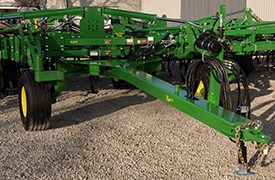 TruSet and single-point depth control
TruSet and single-point depth control
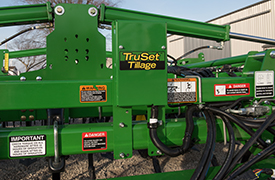 TruSet controller
TruSet controller
Integrated TruSet Tillage technology enables field cultivator operators to adjust sweep depth and down pressure on the active hydraulic rolling baskets while on the go to respond to changing field conditions such as varying soils, heavier residue, and moisture.
With short window of time to perform tillage operations, TruSet can provide significant productivity improvements as operators are able to adjust the field cultivator while covering acres with the push of a button. By responding to conditions as they change throughout the field, TruSet enables operators to generate better-quality tillage performance with the first pass.
Using a GreenStar™ display, a user sees real-time data for sweep depth and basket down pressure for assurance of desired tillage outcomes. Once the actual set point is validated and configured to the display in the cab, operators are able to make independent adjustments as small as one tenth of an inch. Four customizable presets enable operators to save and name different combinations of settings for their most common field conditions.
Single-point depth control is included with the TruSet Tillage system, giving operators the choice of automated or manual adjustments. Hydraulic routings on the 2230 Field Cultivators are designed to allow each implement to feature both TruSet and standard single-point depth control for system redundancy, operator preference, and flexibility at resale.
Components
TruSet is compatible with John Deere and competitive tractors. Depending on the tractor, a compatibility kit may be needed in addition to the TruSet Tillage system. The following chart identifies the components needed to operate TruSet on a 2230LL or 2230FH Field Cultivator with a GreenStar ready tractor.
| TruSet product | John Deere 30 Series and newer Tractors |
John Deere 20 Series Tractors (large frame or IVT™ system) | John Deere 20 Series Tractors (small frame or non IVT) | John Deere 10 Series and older Tractors | Competitive tractors |
| TruSet Tillage system | Yes | Yes | Yes | Yes | Yes |
| TruSet compatibility kit | No | No | Yes | Yes | Yes |
Both the TruSet Tillage system and the compatibility kit will be available as a field-installed option that can be ordered with the field cultivator or through aftermarket parts.
All model years of the 2230LL and 2230FH can be retrofitted with TruSet.
TruSet Tillage requires a GreenStar ready tractor with a supported display. The TruSet Tillage system must have a connection to the tractor ISO connection. Additional TruSet Tillage information:
TruSet™ Side-to-Side feature provides individual section leveling on 2230FH Floating Hitch Field Cultivator
2230FH Floating Hitch Field Cultivator operators have the option to enhance the TruSet Tillage system with individual section leveling functionality. TruSet Side-to-Side will be available as a field-installed option that can be ordered with the 2230FH or through aftermarket parts. The base TruSet Tillage system can also be upgraded to TruSet Side-to-Side on the 2230FH with a conversion kit.
Functionality by depth control option
| Single point | TruSet | TruSet Side-to-Side | |
| One adjustment to change implement depth | X | X | X |
| Mechanical adjustment option | X | X | X |
| In-cab adjustment option | --- | X | X |
| In-cab individual section leveling | --- | --- | X |
| Tillage documentation and prescription | --- | X | X |
Tillage documentation and prescription functionality included with TruSet™ Tillage
With integrated TruSet Tillage technology, 2230 Field Cultivator operators can incorporate documentation and prescription functionality into their tillage operations. The tillage documentation feature will give producers the ability to capture and analyze the field cultivator pass for additional coverage of the crop production cycle. Prescription functionality provides producers the capability to ensure their tillage operations are executed correctly, optimizing their investment in preparing for the next crop.
Operators can document data for the depth of their field cultivator sweeps along with rolling basket down pressure. By creating an as-applied map based off of global positioning system (GPS) data for the job performed by each functional area on the implement, TruSet enables producers to document their tillage passes then later review and analyze the data for future agronomic decisions.
Additionally, the Prescription Creator by Agrian® company, a connected partner tool through the John Deere Operations Center, enables producers to create prescriptions for each functional area on the 2230 Field Cultivators. Data from previous yields, soil surveys, or freehand drawing tools can be used to create prescriptions that will command the implement to the desired depth and pressure settings for optimum agronomic results.
Agrian is a trademark of Agrian, Inc.
Active-hydraulic castering wheels facilitate excellent turning
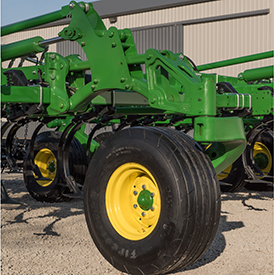 Active-hydraulic castering wheel
Active-hydraulic castering wheel
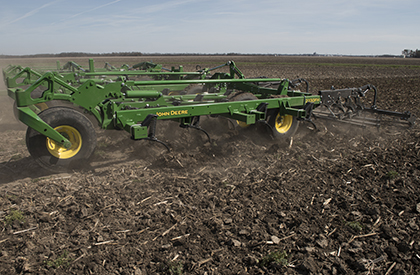 Castering wheels on 2230FH
Castering wheels on 2230FH
Front-mounted active-hydraulic castering depth-control wheels come standard on the 2230FH Floating Hitch Field Cultivator’s centerframe and wings. These active-hydraulic castering wheels rotate a full 360 degrees and provide good stability at the front of the implement and facilitate excellent turning, reducing tire scuffing.
Working together with John Deere’s floating hitch, the active-hydraulic castering wheels help ensure level operation for the 2230FH as the implement is free to follow the contour of the terrain. This frame flexibility over rolling terrain provides more uniform depth integrity fore to aft for:
- Consistent sweep depth
- Thorough seedbed preparation through the entire width and length of the implement
- Consistent chemical placement and mixing
The active-hydraulic castering wheels can be manually adjusted with a turnbuckle. TruSet™ with side-to-side leveling capabilities also enables operators to individually control wing depth and the castering wheels from the cab while on the go.
Regular- and low-transport configuration available for 2230FH
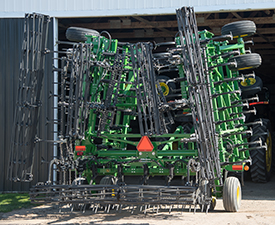 Low-transport field cultivator
Low-transport field cultivator
Low power lines and bridges can be a concern when transporting equipment. The 2230 Field Cultivator lineup includes regular- and low-transport configurations as a solution for transportation concerns.
The 12.95-m (42-ft, 6-in.) 2230FH folds like a five-section implement, but operates like a three-section implement. A small wing is added to these implements. This allows them to have an extra fold to achieve the tight and narrow transport dimensions. When the implement is unfolded for operation, the small, outer-wings lock rigid to allow for three-section operation.
Another advantage of the low-transport models is operation in uneven terrain. The low-transport models allow for the rigid wing to follow the contour of the ground.
The regular-transport model features an 18.44-m (60-ft, 6-in.) working width on a 4.6-m (15-ft) mainframe that allows for a lower transport height compared to the other 18.44-m (60-ft, 6-in.) configuration.
| Configuration | Working width | Transport height | Transport width |
| Low transport | 12.95 m (42 ft, 6 in.) | 4.22 m (13 ft, 10 in.) | 5.33 m (17 ft, 6 in.) |
| Regular transport | 18.44 m (60 ft, 6 in.) | 4.75 m (15 ft, 7 in.) | 7.16 m (23 ft, 6 in.) |
Features
Wide range of working widths available to match acreage and horsepower requirements
 Five-section configuration
Five-section configuration
At 16-km/h (10-mph) working speeds, the 2230LL can cover up to 29.5 hectares (73 acres) per hour enabling producers to size their implement for their unique productivity and agronomic needs.
The 2230LL is available in sizes ranging from 7.2 to 18.4 m (23 ft, 6 in. to 60 ft, 6 in.). Horsepower requirements range from 19.6 to 29.4 kW/m (8 to 12 hp-ft), depending on the soil, depth, and speed.
Three-section configurations
| Working widths | Centerframe size | Productivity per hour at 16 km/h (10 mph) |
| 7.16 m (23 ft, 6 in.) | 2.74 m (9 ft) | 11.3 hectares (28 acres) |
| 7.77 m (25 ft, 6 in.) | 12.5 hectares (31 acres) | |
| 8.38 m (27 ft, 6 in.) | 13.6 hectares (33 acres) | |
| 8.99 m (29 ft, 6 in.) | 14.6 hectares (36 acres) | |
| 9.60 m (31 ft, 6 in.) | 3.35 m (11 ft) | 15.4 hectares (38 acres) |
| 10.21 m (33 ft, 6 in.) | 16.6 hectares (41 acres) | |
| 10.82 m (35 ft, 6 in.) | 17.4 hectares (43 acres) | |
| 11.73 m (38 ft, 6 in.) low transport | 2.74 m (9 ft) | 19.0 hectares (47 acres) |
| 13.25 m (43 ft, 6 in.) low transport | 3.35 m (11 ft) | 21.4 hectares (53 acres) |
Five-section configurations
| Working widths | Centerframe size | Productivity per hour at 16 km/h (10 mph) |
| 12.95 m (42 ft, 6 in.) | 2.74 m (9 ft) | 21.0 hectares (52 acres) |
| 14.17 m (46 ft, 6 in.) | 22.7 hectares (56 acres) | |
| 15.39 m (50 ft, 6 in.) | 24.7 hectares (61 acres) | |
| 16.00 m (52 ft, 6 in.) | 3.35 m (11 ft) | 25.9 hectares (64 acres) |
| 17.22 m (56 ft, 6 in.) | 27.5 hectares (68 acres) | |
| 18.44 m (60 ft, 6 in.) | 29.5 hectares (73 acres) |
Level-lift™ frame ensures even operation through all operating depths
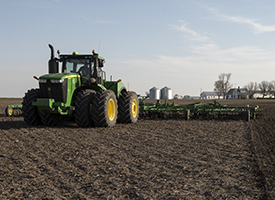 2230LL Field Cultivator
2230LL Field Cultivator
The Level-lift hitch ensures a level operation through all operating depths. It also provides consistent gang and sweep depth fore to aft for thorough seedbed preparation. This quick, easy adjustment ensures a flat seedbed floor and level soil profile for planting.
The combination of the sweep and harrow functions promotes consistent and uniform chemical placement and mixing. The T-hitch enables easy turnbuckle adjustment for fast tractor changeover and quick implement leveling fore to aft.
The heavy-duty T-hitch allows for tighter turning, decreasing the amount of headlands required for quick turns on the end. The T-hitch also houses the hoses and wiring harness, protecting them from crop and incidental tire contact.
True 152-mm (6-in.) split-the-middle spacing provides complete field coverage
 TruPosition™ standards on 2230 Field Cultivator
TruPosition™ standards on 2230 Field Cultivator
 152-mm (6-in.) split-the-middle shank spacing
152-mm (6-in.) split-the-middle shank spacing
Thanks to an updated frame design that enables true 152-mm (6-in.) split-the-middle shank spacing, the 2230 Field Cultivators can maintain consistent depth and evenly cover the field to achieve an optimal seedbed and manage weeds.
Seedbed preparation
Even at high speeds and in tough field conditions, the TruPosition C-shanks with 91 kg (200 lb) of trip force minimize side-to-side movement and provide the operator better control of the soil profile for improved leveling capabilities.
These shanks provide a full tillage cut across the entire width of the implement. The shanks stay firmly planted in tough soils without quickly relieving. As a result, the soil is mixed completely and streaks are reduced. This helps producers maximize their productivity and create flat seedbeds for smooth planter operation and consistent seed depth.
Weed management
The even 152-mm (6-in.) split-the-middle shank spacing enables the 2230 Field Cultivator to minimize the potential of remaining strips of weeds that survive the tillage pass. With a field cultivator pass just prior to planting/seeding, the crop can emerge into a weed-free field that gives it the best chance to reach canopy ahead of the weeds.
If some weeds emerge and a post-emergence herbicide is needed, weeds should be smaller and easier to control. As a result, the field cultivator pass helps keep weed management costs under control and helps preserve crop yield potential.
Spacing options
 True 152-mm (6-in.) split-the-middle spacing
True 152-mm (6-in.) split-the-middle spacing
152-mm (6-in.) shank spacing base equipment on the 2230LL and 2230FH. Additional options for implement customization include:
- 229-mm (9-in.) shank spacing
- 114-mm (4.5-in.) s-tine spacing (on select configurations)
ProFinish™ Leveling System offers wide range of rear harrows to meet agronomic needs

The ProFinish Leveling System offers a wide range of rear harrows to meet agronomic needs.
Depending on agronomic needs, producers have a choice of six rear harrow options included in the ProFinish Leveling System on the 2230 Field Cultivators.
| Capabilities | 4-bar coil-tine harrow | 6-bar spike-tooth harrow | 3-bar coil-tine with round-bar basket | 3-bar coil-tine with flat-bar basket | 3-bar spike-tooth with round-bar basket | 3-bar spike-tooth with flat-bar basket |
| Level seedbed | Good | Better | Best | Best | Best | Best |
| Firm seedbed | Fair | Good | Best | Better | Best | Better |
| Handle residue | Best | Better | Best | Best | Better | Better |
| Break up clods | Good | Better | Better | Best | Better | Best |
| Handle moisture/wet soil | Best | Better | Good | Good | Good | Good |
| Handle rocks | Best | Good | Better | Good | Better | Good |
TruSet™ Tillage provides precise depth and pressure control from the cab on the go
 TruSet and single-point depth control
TruSet and single-point depth control
 TruSet controller
TruSet controller
Integrated TruSet Tillage technology enables field cultivator operators to adjust sweep depth and down pressure on the active hydraulic rolling baskets while on the go to respond to changing field conditions such as varying soils, heavier residue, and moisture.
With short window of time to perform tillage operations, TruSet can provide significant productivity improvements as operators are able to adjust the field cultivator while covering acres with the push of a button. By responding to conditions as they change throughout the field, TruSet enables operators to generate better-quality tillage performance with the first pass.
Using a GreenStar™ display, a user sees real-time data for sweep depth and basket down pressure for assurance of desired tillage outcomes. Once the actual set point is validated and configured to the display in the cab, operators are able to make independent adjustments as small as one tenth of an inch. Four customizable presets enable operators to save and name different combinations of settings for their most common field conditions.
Single-point depth control is included with the TruSet Tillage system, giving operators the choice of automated or manual adjustments. Hydraulic routings on the 2230 Field Cultivators are designed to allow each implement to feature both TruSet and standard single-point depth control for system redundancy, operator preference, and flexibility at resale.
Components
TruSet is compatible with John Deere and competitive tractors. Depending on the tractor, a compatibility kit may be needed in addition to the TruSet Tillage system. The following chart identifies the components needed to operate TruSet on a 2230LL or 2230FH Field Cultivator with a GreenStar ready tractor.
| TruSet product | John Deere 30 Series and newer Tractors |
John Deere 20 Series Tractors (large frame or IVT™ system) | John Deere 20 Series Tractors (small frame or non IVT) | John Deere 10 Series and older Tractors | Competitive tractors |
| TruSet Tillage system | Yes | Yes | Yes | Yes | Yes |
| TruSet compatibility kit | No | No | Yes | Yes | Yes |
Both the TruSet Tillage system and the compatibility kit will be available as a field-installed option that can be ordered with the field cultivator or through aftermarket parts.
All model years of the 2230LL and 2230FH can be retrofitted with TruSet.
TruSet Tillage requires a GreenStar ready tractor with a supported display. The TruSet Tillage system must have a connection to the tractor ISO connection. Additional TruSet Tillage information:
Tillage documentation and prescription functionality included with TruSet™ Tillage
With integrated TruSet Tillage technology, 2230 Field Cultivator operators can incorporate documentation and prescription functionality into their tillage operations. The tillage documentation feature will give producers the ability to capture and analyze the field cultivator pass for additional coverage of the crop production cycle. Prescription functionality provides producers the capability to ensure their tillage operations are executed correctly, optimizing their investment in preparing for the next crop.
Operators can document data for the depth of their field cultivator sweeps along with rolling basket down pressure. By creating an as-applied map based off of global positioning system (GPS) data for the job performed by each functional area on the implement, TruSet enables producers to document their tillage passes then later review and analyze the data for future agronomic decisions.
Additionally, the Prescription Creator by Agrian® company, a connected partner tool through the John Deere Operations Center, enables producers to create prescriptions for each functional area on the 2230 Field Cultivators. Data from previous yields, soil surveys, or freehand drawing tools can be used to create prescriptions that will command the implement to the desired depth and pressure settings for optimum agronomic results.
Agrian is a trademark of Agrian, Inc.
Wing stabilizer wheels ensure steady and consistent operation
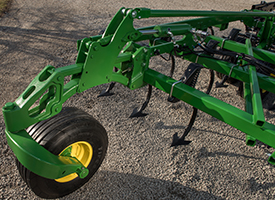 Active-hydraulic castering wheel on 2230FH
Active-hydraulic castering wheel on 2230FH
 Mechanical stabilizer wheel on 2230LL
Mechanical stabilizer wheel on 2230LL
Wing stabilizer wheels are recommended when producers encounter rolling ground conditions, terraces, or when the tool is operated at speeds above 11 km/h (7 mph).
Stabilizer wheel options and quantities are dependent on the model.
On the 2230LL Level-lift™ Field Cultivator, two mechanical wing stabilizer wheels are included on the outer wings for all five-section configurations. Both three-section and five-section configurations have the option to add stabilizer wheels to the inner wings.
On the 2230FH Floating Hitch Field Cultivator, the 12.95-m (42-ft, 6-in.) low-transport configuration has the option of adding a pair of mechanical stabilizer wheels. The active-hydraulic castering wheels are included in base equipment for the inner and outer wings on the 2230FH.
Radial and bias-ply tire options are available for mechanical stabilizer wheels and active-hydraulic castering wheels.
NOTE:Not all tire options are available for all configurations.
| Configuration | Mechanical stabilizer wheels | Active-hydraulic castering wheels | |||
| Base quantity | Optional quantity | Base quantity | Optional quantity | ||
| 2230LL | Three-section | --- | 2 | --- | --- |
| Five-section | 2 | 2 | --- | --- | |
| Low transport | --- | 2 | --- | --- | |
| 2230FH | Three-section | --- | --- | 4 | --- |
| Five-section | --- | --- | 6 | --- | |
| Low transport | --- | 2 | 4 | --- | |
| Radial Tire Sizes | |||
| Main Frame | Wing Frame |
||
| 2230LL | Three-section | N/A | IF280/80 R15 Six bolt |
| Five-section | IF280/70 R15 |
IF280/70 R15 |
|
| Low transport | N/A | IF280/80 R15 Six bolt |
|
| 2230FH | Three-section | IF280/70 R15 |
IF280/70 R15 |
| Five-section | IF320/70 R15 |
IF320/70 R15 |
|
| Low transport | IF320/70 R15 |
IF320/70 R15 |
|
| Bias Tire Sizes | |||
| Main Frame | Wing Frame |
||
| 2230LL | Three-section | N/A | 9.5L-15 LD D Six bolt |
| Five-section | 9.5L-15 LD D |
9.5L-15 LD D |
|
| Low transport | N/A | 9.5L-15 LD D Six bolt |
|
| 2230FH | Three-section | 11L-15 FI LR D |
11L-15 FI LR D |
| Five-section | 12.5L-15 FI LR F |
12.5L-15 FI LR D |
|
| Low transport | 12.5L-15 FI LR D |
12.5L-15 FI LR D |
|
Rear hitch compatible with all 2230 configurations and rear harrows
 Rear hitch
Rear hitch
A substantial rear hitch is available to give the 2230 the versatility to pull the 200 Seedbed Finisher or other rear attachments. The rear hitch includes:
- Rectangular tube construction
- Telescoping hitch
- Serviceable drawbar
- 453-kg (1000-lb) tongue weight rating
- 13,000 gross vehicle weight (GVW) rating for five-section machines; 10,000 gross vehicle weight (GVW) rating for three-section machines
- Wiring harness for transport lights
- Hydraulic hoses and couplers
- Higher load safety chain between tractor and implement
The rear hitch is fully compatible with all 2230 rear harrow configurations available in the ProFinish™ Leveling System.
Low-transport configurations available for 2230LL
 2230LL in transport
2230LL in transport
 Low-transport configuration
Low-transport configuration
Low power lines and bridges can be a concern when transporting equipment. The 2230 Field Cultivator lineup includes low-transport configurations as a solution for transportation concerns.
The 2230LL has two low-transport configurations. These implements fold like a five-section implement, but operate like a three-section implement for improved transportability thanks to the addition of small outer wings that lock rigid for field operation.
Another advantage of the low-transport models is operation over uneven terrain. The low-transport models allow for the rigid wing to follow the contour of the ground.
| Working width | Transport height | Transport width |
| 11.7 m (38 ft, 6 in.) | 4.1 m (13 ft, 6 in.) | 4.3 m (14 ft, 0 in.) |
| 13.3 m (43 ft, 6 in.) | 4.4 m (14 ft, 4 in.) | 5.5 m (18 ft, 0 in.) |
Features
John Deere ActiveCal™ system
 ActiveCal initiated on a C850
ActiveCal initiated on a C850
 ActiveCal initiated on an N500C
ActiveCal initiated on an N500C
The more frequently calibration is completed, the more accurate a seeder will be. A number of variables, including product weight and changing climate conditions throughout the day, will have an effect on any volumetric metering system; with the John Deere ActiveCal system, calibration can be done from the cab of the tractor, while seeding, to minimize the variation in product metering.
The process to calibrate the implement starts with the Gen 4 4600 CommandCenter™ Display in the work setup page, where the operator defines product types, rates and selects meter rollers. Based on information entered into the work setup page, a preconfigured meter displacement value (MDV) will populate per meter. An initial manual calibration will give the most accurate MDV to start with. However, the preconfigured MDV will be a good starting point for growers who do not wish to manually calibrate.
The operator engages ActiveCal while stationary by selecting the button on the screen and then begins seeding. When enough product has been metered out, typically after about 8-12 acres, the Gen 4 CommandCenter will prompt the operator to stop when convenient to do so. At that time, the data points are calculated and a new MDV with percent difference is displayed on screen. The operator can accept or reject the new MDV. If accepted, the system automatically calibrates to the new MDV. If rejected, the system continues at the previously calibrated numbers.
 Tank scales provide tank weights to ActiveCal system
Tank scales provide tank weights to ActiveCal system
Camera ready
Monitoring the product levels in tanks has never been easier with the camera-ready feature of the 1910 and C850 Air Carts. The carts come pre-wired to accept a camera in each tank and on the rear of the machine. Cameras allow the operator to conveniently monitor product levels in each tank, which is especially reassuring when product levels are low. Cameras also provide the operator with visibility behind the cart when traveling down the road.
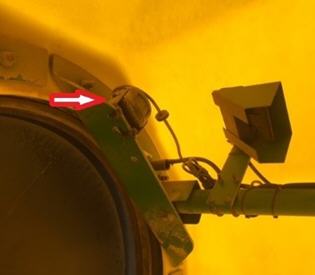 Camera locations on the 1910 Air Cart
Camera locations on the 1910 Air Cart

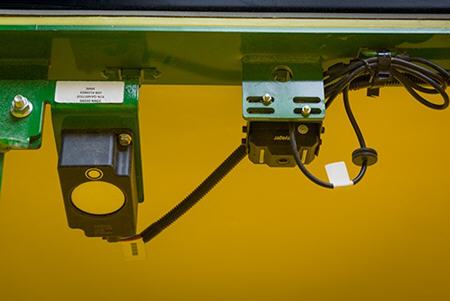 Camera location on the C850 Air Cart
Camera location on the C850 Air Cart
For the 1910 Air Carts, the producer has the choice of linking up to three cameras (CabCAM™ or Voyager® cameras) to a GreenStar™ 3 2630 Display or up to four Voyager cameras on a Generation 4 4600 CommandCenter™ Display or 4640 Universal Display. If the producer wants to view more than four cameras, a producer-purchased camera display will be needed.
For C850 Air Carts, the producer can use up to four Voyager cameras on a Generation 4 4600 CommandCenter Display or 4640 Universal Display. If the producer wants to view more than four cameras, a producer-purchased camera display will be needed.
NOTE: Generation 4 displays only support Voyager cameras.
While the 1910 and C850 Air Carts come pre-wired to adapt cameras, additional harnesses are necessary for connecting to the tractor, and a tool overlay harness will be needed for tow-behind carts. Please use the option codes below if ordering on a new machine or the part numbers for configuring an existing machine.
Option code |
Description |
Parts |
9610 |
Tool overlay harness |
AA94564 |
9615 |
Gen 4 4600 CommandCenter Display tractor cab harness |
AA93727 (order one per camera) AA94316 |
9620 |
4640 Universal Display tractor cab harness |
SWTY268456 AA94316 |
9625 |
GreenStar 3 2630 Display tractor cab harness | AA94319 AA94316 |
Some carts may require SWVOSCCAM and AA96311, a Voyager connector to CabCAM connector, on the rear of the cart.
CabCAM is a trademark of ATI Products, Inc. Voyager is a trademark of ASA Electronics, LLC.
Cart side display functions
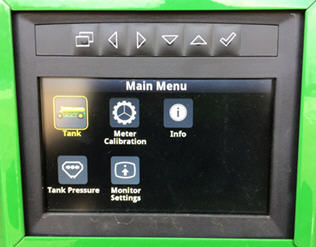 Main menu on the C850 Cart side display
Main menu on the C850 Cart side display
The durable display on the side of the cart will make filling and calibration easier than before. Selecting the menu button on the far left will take the grower to the main menu where they can select:
- Tank: shows product weight and tank fill level
- Meter calibration: preform a bag calibration without going back and forth to the cab to make inputs on the Gen 4 CommandCenter™ display
- Info: shows display and software information
- Tank pressure: shows the differential pressure between the tank and the meter for each individual tank
- Monitor settings: allows the customer to adjust the brightness of the display
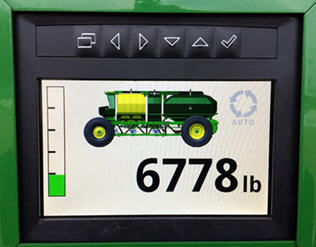 Tank screen
Tank screen
Tank weights and bin level will be shown on the first screen when the display is powered on. Navigating from one tank weight to another will be done by pressing the left and right arrow buttons.
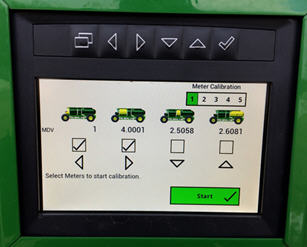 Meter calibration
Meter calibration
Meter calibration can be done cart side. To select the tank or tanks that need to be calibrated, press the display button that matches the icon below the respective tank on the screen.
 Tank pressure screen
Tank pressure screen
The digital screen replaces the mechanical tank pressure gauges on previous carts.
Tank capacity and design
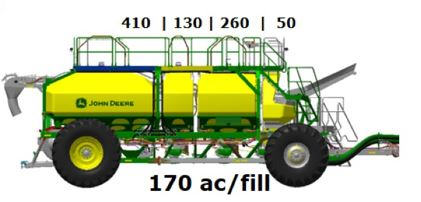 Tank capacity measured in bushels
Tank capacity measured in bushels
The total capacity of the C850 is 29,953 L (850 bu), measured by conveying product into the tank. The front tank is dedicated for low rate applications and holds 1762 L (50 bu). The remaining three tanks in order of front to rear are 9162 L (260 bu), 4581 L (130 bu), and 14,448 L (410 bu).
John Deere air cart tanks are solid molded polymer, known for superior corrosion resistance compared to steel while providing semi translucency allowing for visual verification of product level in day-time operation. Each tank is mounted in a cradle frame to eliminate interference between each other. The polymer material does not require weldments like on steel tanks. Weldments on steel tanks are prone to failure over time as the metal is fatigued under stress.
The improved top bevel design on tanks allow for greater capacity and meets the 29,953-L (850-bu) capacity without the need for shoveling product into the corners while conveyor filling.
Each tank has a wide single opening, which means it is easy for access for the conveyor and entry to the tank. Inside each tank is a ladder for cleanout access. Ladders in the tanks have been designed so that material cannot build up on steps. Top rails have been capped and sloped to ensure product sheds from the surface. When cleaning out the cart, the tanks slope steeply at bottom for product to flow easily and each tank is accessible for fill and cleanout with the conveyor.
Tanks come equipped with digital pressure sensor, ultrasonic bin level sensing, and camera-ready harnesses mounted from the factory.
Ultrasonic bin level sensing
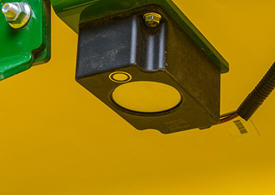 Ultrasonic bin level sensor
Ultrasonic bin level sensor
 Ultrasonic waves are reflected off product in the tank
Ultrasonic waves are reflected off product in the tank
The John Deere ultrasonic bin level sensing system will increase the accuracy of bin level read outs in the cab and on the cart side display compared to the paddle design. The accuracy of this system is within 10 percent of actual product in the tank. Product in the tank is measured utilizing high-frequency sound waves (ultrasonic) that are emitted from the unit and received back when they reverberate off the product in the tank. These sound waves generate a digital signal which can be mapped across the angle of repose for the product in the tank. Using calculus volume can be determined from the convex slope determined from the ultrasonic frequencies. When metering two products into one airstream, ultrasonic is able to improve the accuracy of detection up to 50 percent more than traditional paddle sensors.
Wireless-controlled hydraulic conveyance system with low-profile hopper
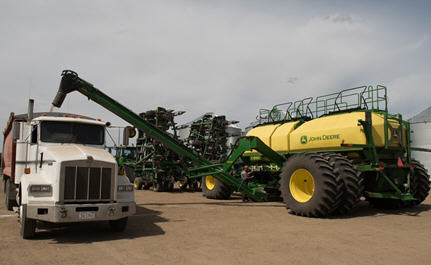 Unloading product from tanks
Unloading product from tanks
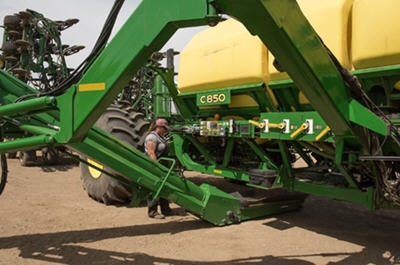 Unloading product from tanks
Unloading product from tanks
The C850 comes standard with the wireless-controlled hydraulic conveyance system with a low-profile hopper. Maneuvering the conveyor can be done from the wireless conveyor remote or the remote tethered to the cart. With five pivot points on the arm, all tanks can be filled from one spot. The pivot points also allow the conveyor to be easily positioned and moved when filling from a seed tender.
This conveyor moves up to 3524 L (100 bu) of product in a minute with a 40.6-cm (16-in.) belt inside the 30.5-cm (12-in.) tube. By moving the hopper under meter, the conveyor can be used for clean out on each tank as well.
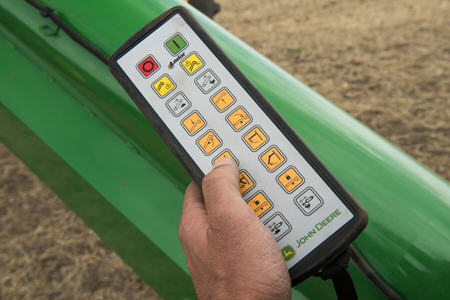 Remote to operate conveyor
Remote to operate conveyor
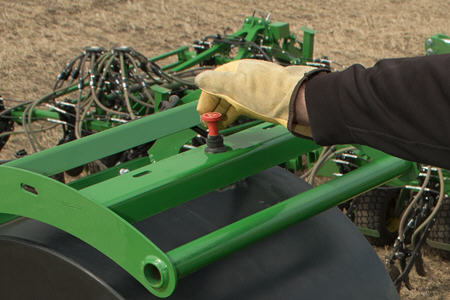 Conveyer shut off switch
Conveyer shut off switch
The shut-off switches on the conveyor are located at the bottom of the tube, above the hopper and at the top of the conveyor near the spout. Filling at night is easy with the light-emitting diode (LED) 900-lumen lights on the cart and conveyor conveniently placed to illuminate each meter, the stairway and platform.
Easy-to-operate tank lids
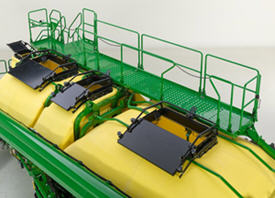 Tank lids in open position
Tank lids in open position
The C850 has five tank lids to make filling convenient and quick. The three back tank lids are operated by pushing forward on the foot pedal and straight down on the handle. The lid slides out of the way, contouring the shape of the tank, so it does not interfere with the conveyor. The tank lids seal tight by pulling upward on the handle and stepping back on the foot pedal. The three back tank lids offer a wide opening, making an easy job out of placing the conveyor in the right place during fills. The design is a single per tank design, providing for faster fill times.
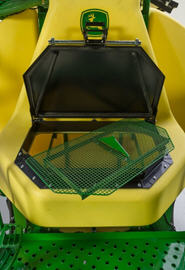 Bottom tank lid and bag splitter on front tank
Bottom tank lid and bag splitter on front tank
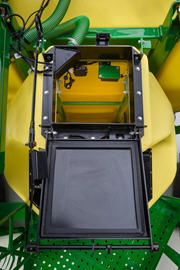 Top tank lid of front tank
Top tank lid of front tank
The front 1762-L (50-bu) tank has two options to make loading low rate products easier. If the grower is filling the tank with bags, the front lid is accessible from the lower platform of the cart. The two front railings of the cart can be removed to allow for a truck to bring bags directly to the platform. As pictured above, the bottom fill location of the front tank has a bag splitter.
To fill the front tank with a conveyor, the top tank lid is easily reached with the hydraulic conveyance system.
Stairway and platform
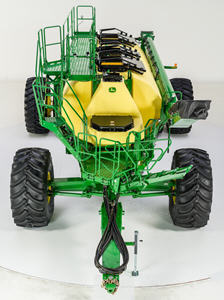 Platform
Platform
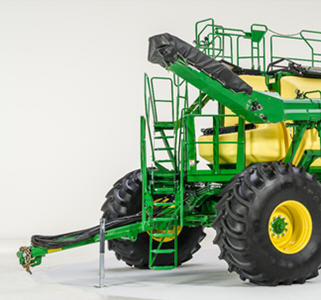 Stairs to the platform
Stairs to the platform
The stairs to the platform are 33.02 cm (13 in.) from the ground and feature wide, tall, and sturdy handrails that will support operators as they carry bags to the dedicated low-rate, 1762-L (50-bu) tank on the bottom platform. A wheel-speed sensor will automatically fold the stairs as the air seeding train moves. The powered stairs also have a manual release. The stairs are equipped with compression springs to make folding up the stairs manually an effortless task.
The lower platform was designed with comfort and convenience in mind. The front two handrails can be easily removed so operators can load from a skid steer or the back of the pickup truck. The stairs allow access to the mini tank when carrying seed bags. The platform has room designed for seed bag storage with cut outs for tie-down straps in the railing.
To improve scale accuracy, the upper platform has been isolated from the tanks to eliminate interference. With that design, movement of the platform can be expected. The handrail system is foldable so the handrails are flush with the tank lids.
Tires
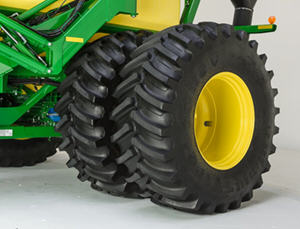 Dual rear tires on the C850
Dual rear tires on the C850
 Single front tire on the C850
Single front tire on the C850
The C850 comes equipped with rear dual Mitas® 800/70R38 SFT tires and front single Mitas 800/70R38 SFT tires as a high-floatation, low-compaction solution. The Mitas tires run at an inflation pressure of 1.3 bar (19 psi). Super flexion tire (SFT) technology means that the sidewalls on the tire are developed with additional reinforcement and superior rubber compounds, which enables the tires to run at a very low pressure while under higher loads without damaging the sidewalls. By running at lower pressure, the tire is able to flex its sidewalls and squat, allowing for a much wider footprint and improving floatation.
An optional tire package for even greater floatation and decreased compaction includes rear dual Firestone® increased flexion (IF) 850/75R42 CFO tires and front single IF 900/75R32 CFO tires. The Firestone package allows for increased air capacity, which provides greater floatation. A proprietary side wall compound and radials allow for a lower tire pressure (0.8ba [12 psi]) which provides lower compaction across a wider footprint.
To see how the tire pressures on the C850 Air Cart compare to the 1910 Commodity Cart, please view the tire pressure guide.
Below is a test conducted by Firestone comparing the impact different size tires have on average flat plate areas and pressures. While it is not an exact comparison to the Mitas tires, which run at a lower pressure than what is used in the study, it gives a general illustration of the additional contact area of the high floatation tires.
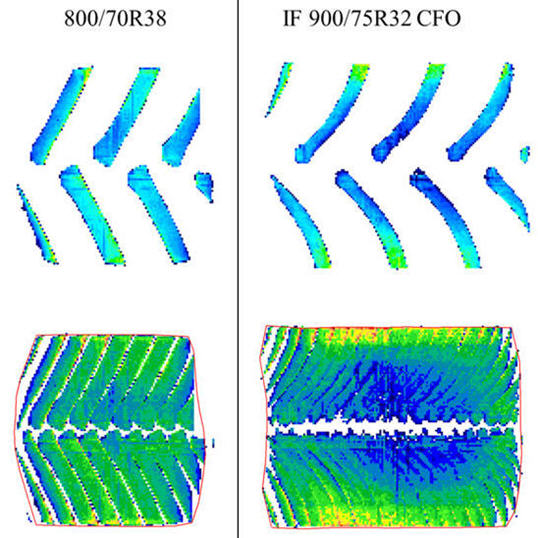 Front position tire pressure illustration
Front position tire pressure illustration
| Front position comparison | ||
| Tire size | 800/700R38 | IF 900/75R32 CFO |
| Load | 8913.1 kg (19,650 lb) | 8913.1 kg (19,650 lb) |
| Inflation | 1.8 bar (26 psi) | 0.8 bar (12 psi) |
| Total area | 5038.7 cm2 (781 sq in.) | 7580.6 cm2 (1175 sq in.) |
| Contact area | 1470.3 cm2 (227.9 sq in.) | 1628.4 cm2 (252.4 sq in.) |
| Average pressure | 1.7 bar (25.1 psi) | 1.15 bar (16.7 psi) |
 Rear position tire pressure illustration
Rear position tire pressure illustration
| Rear position comparison | ||
| Tire size | 800/700R38 | IF 850/75R42 CFO |
| Load | 7407.2 kg (16,330 lb) | 7407.2 kg (16,330 lb) |
| Inflation | 1.65 bar (24 psi) | 0.8 bar (12 psi) |
| Total area | 4710 cm2 (730 sq in.) | 7451.6 cm2 (1115 sq in.) |
| Contact area | 1362.6 cm2 (211.2 sq in.) | 1950.3 cm2 (302.3 sq in.) |
| Average pressure | 1.54 bar (22.4 psi) | 0.97 bar (14.1 psi) |
 Wheel measurements in mm
Wheel measurements in mm
Mitas is a trademark of Mitas, Akciova Spolecnost Corporation. Firestone is a trademark of Bridgestone Americas Tire Operations, LLC.
SectionCommand™ system saves seed and fertilizer input costs
SectionCommand controls seed and fertilizer overlaps and skips
Controlling input costs and improving productivity are key producer requirements today. SectionCommand is an effective, integrated John Deere solution designed to meet these intensifying needs. SectionCommand manages both seed and fertilizer application by minimizing overlaps and skips while seeding with the John Deere 1910 and C850 Air Carts.
Owner benefits include:
- Improved consistency of crop maturity at harvest
- Improved consistency during emergence and growing season
- Reduced seed input cost
- Reduced fertilizer input cost
- Increased time between fills due to input savings
SectionCommand is base equipment with optional deduct on all John Deere 1910 and C850 Air Carts. Each tank and meter will receive SectionCommand components. A two-tank cart will control sections out of both tanks, a three-tank cart will control sections out of all three tanks, and the C850 cart will control sections out of all four tanks. SectionCommand is also available as an attachment for field conversion (AFC) for all 1910 hydraulic drive carts. See AFC kit story for more information.
SectionCommand controls seed and fertilizer output by closing and opening gates on the bottom side of the meter. When the gates are open, commodity is metered out, and when closed, commodity stays and continues to rotate within the meter. The meter stays full at all times so immediately when the gate opens, the commodity can flow into the primaries and out to the tool. Since each meter section has its own gate, application rates and row-to-row accuracy are not compromised. The gates are utilized to control commodity output on all sections. Once the last gate needs closed, the entire meter will stop turning, stopping product flow.
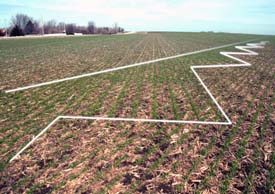 Seeded fields photo
Seeded fields photo

When commanded, electric over-hydraulic solenoids engage actuators to instantaneously close the gate for the needed section. The actuators are powered via hydraulics from the same circuit as the hydraulic drive motors. When power is cut, oil is diverted to retract the actuators and open the gates. The retraction is both powered and spring assisted, so it will always default to the seeding position. The oil from SectionCommand drains back through the fan motor case drain line and is coupled with an accumulator on the valve block to provide extra drainage capacity.
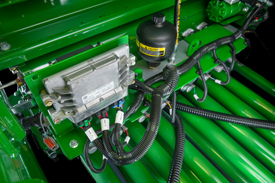 SectionCommand components as seen on back side of meter
SectionCommand components as seen on back side of meter
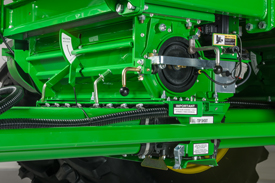 SectionCommand components as seen on front side of meter
SectionCommand components as seen on front side of meter
SectionCommand incorporates gate detection, which gives producers the satisfaction of knowing the gates are in position as commanded. Magnets on the back side of the gates are used in close proximity to the gate detection sensors to determine if the gates are open or closed. Should a gate not be in the commanded position, an alarm will alert the operator of the gate(s) in question. The blockage warning system works in conjunction with SectionCommand to give further confidence whether a given section is seeding or not when commanded.
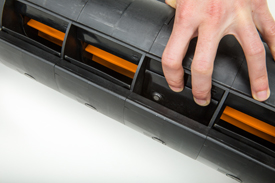 SectionCommand meter cartridge showing one gate closed and magnet on backside of gate
SectionCommand meter cartridge showing one gate closed and magnet on backside of gate
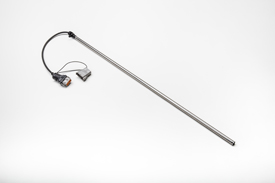 Gate detection sensor
Gate detection sensor
For maximum performance, SectionCommand should be controlled through John Deere Section Control. Coupling SectionCommand with John Deere Section Control provides the ultimate in precision seeding and productivity. If a Section Control activation is held by the producer, that same activation can be utilized for SectionCommand.
SectionCommand introduces the orange roller, which has the same number of flutes and spacing as the blue roller, but shorter flutes. It is for use only with SectionCommand when seeding seeds larger than 6 mm (0.25 in.) in diameter (soybeans, chick peas, etc.). The orange roller is not for use with cereal grains or fertilizer.
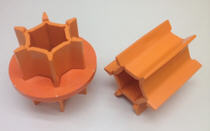 Orange roller, for use only with large seeds and SectionCommand
Orange roller, for use only with large seeds and SectionCommand
SectionCommand equalizer
Due to the varying lengths of product delivery hose used across the drill, SectionCommand has a built in equalizer feature to ensure consistent product delivery across the width of the drill when entering and exiting headlands. The software allows the producer to set the on/off product delivery times separately for the outermost opener and the innermost opener on the drill. Product delivery times are inputted for each tank on the cart, and the software creates a time delay for actuation of the gates.
Please see the Using SectionCommand video for more information.
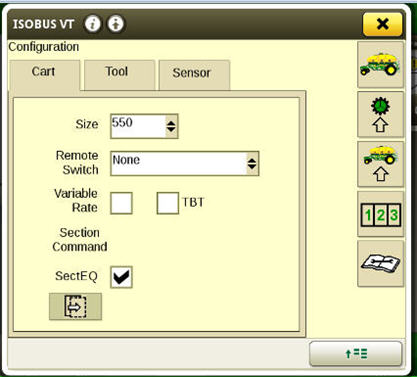 Enabling SectionCommand equalizer
Enabling SectionCommand equalizer
 Input on/off times for outer opener versus inner opener on each tank
Input on/off times for outer opener versus inner opener on each tank
NOTE: Please reference CCMS solution 111434 for more information.
The metering system provides accuracy and convenience
A meter cartridge at each tank effectively meters seed or fertilizer into the primary manifold. Air carries the material to the secondary distributor for delivery to the openers on the seeding tool.
Meters are contained in a cartridge for convenient removal and are color coded for easy identification.
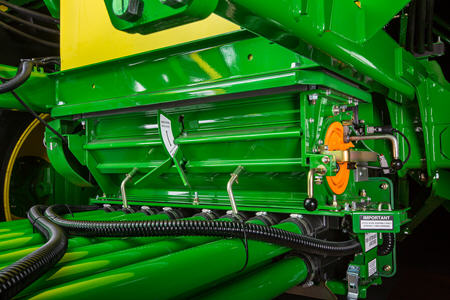 Metering system
Metering system
A manual half-width disconnect is incorporated into the 1910 meter system:
-
Allows one-half of the metering system to be manually shut off for irregular shaped headlands, point rows, etc. on mechanical drive carts.
- Allows the meter cartridge to be removed with material still in the tank(s).
- Allows tanks to be emptied with meter and primary manifold in place.
 Electric actuator on the C850 Air Cart
Electric actuator on the C850 Air Cart
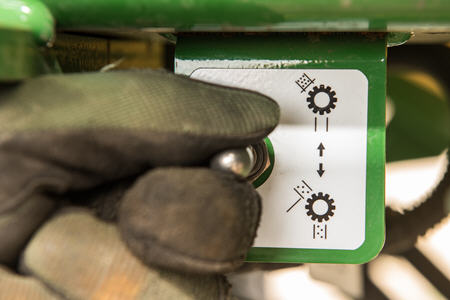
On the C850 Air Cart an electric actuator controls product flow from the tank to the meter housing:
- Allows complete shut off of product flow with little effort
- Allows the meter cartridge to be removed with material still in the tank(s).
- Allows tanks to be emptied with meter and primary manifold in place.
Features
Choice of auger or conveyor
 254-mm (10-in.) auger on 15,200-L (430-bu) cart
254-mm (10-in.) auger on 15,200-L (430-bu) cart

As growers look for ways to increase efficiencies, one solution is to shorten the time required to fill. By increasing pit stop productivity, growers are able to cover more ground per day.
Producers have the choice of an auger or conveyor to fit their needs.
The 254-mm (10-in.) auger:
- Available on the 12,300-L (350-bu), 15,200-L (430-bu), and 19,400-L (550-bu) carts
- Loading rate 1800-L (50-bu) per minute
- Balanced for safe, convenient movement between storage and filling positions
- Able to fit under the meters for tank cleanout
The 203-mm (8-in.) auger:
- Available on 8,800-L (250-bu), 9,500-L (270-bu), and 12,000-L (340-bu) carts
- 700-L (20-bu) per minute fill rate
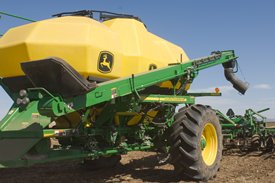 305-mm (12-in.) conveyor
305-mm (12-in.) conveyor

The 305-mm (12-in.) conveyor provides producers with a gentle conveyance system:
- 305-mm (12-in.) wide belt with risers spaced on 150-mm (6-in.)
- 1400-L (40-bu) per minute fill rate
- Can also transfer fertilizer
- Cleanout trap door at the bottom
- Optional on all 1910 carts
The telescoping spout provides the following benefits:
- Decreases fill time
- Easily fills each tank to the very top
- Improves movement when going from one tank to another, matching the tank height
The metering system provides accuracy and convenience
A meter cartridge at each tank effectively meters seed or fertilizer into the primary manifold. Air carries the material to the secondary distributor for delivery to the openers on the seeding tool.
Meters are contained in a cartridge for convenient removal and are color coded for easy identification.
 Metering system
Metering system
A manual half-width disconnect is incorporated into the 1910 meter system:
-
Allows one-half of the metering system to be manually shut off for irregular shaped headlands, point rows, etc. on mechanical drive carts.
- Allows the meter cartridge to be removed with material still in the tank(s).
- Allows tanks to be emptied with meter and primary manifold in place.
 Electric actuator on the C850 Air Cart
Electric actuator on the C850 Air Cart

On the C850 Air Cart an electric actuator controls product flow from the tank to the meter housing:
- Allows complete shut off of product flow with little effort
- Allows the meter cartridge to be removed with material still in the tank(s).
- Allows tanks to be emptied with meter and primary manifold in place.
Stairway and platform offer convenience and easy access
The easy-to-navigate staircase and large platform provide easy access to tank lids.
On tow-between carts, there is convenient front access to the platform, with step-over access when going from side-to-side over the front hitch.
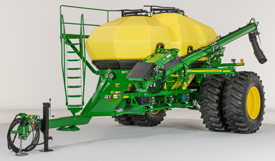 Tow-between cart, front access
Tow-between cart, front access
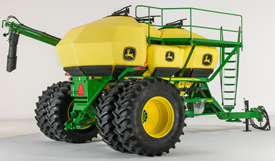 Tow-between cart, front access
Tow-between cart, front access
 Tow-behind cart, rear access
Tow-behind cart, rear access
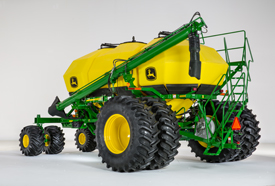 Tow-behind cart, rear access
Tow-behind cart, rear access
Efficient air system ensures consistent product delivery
Secondary manifolds
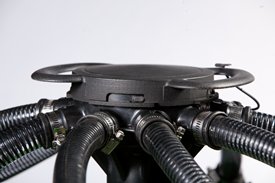 Secondary manifold on seeding tool
Secondary manifold on seeding tool
 One-piece removable lid with tether
One-piece removable lid with tether
Secondary manifolds with 25-mm (1-in.) diameter lines evenly distribute the seed and/or fertilizer from the primary manifold(s) to the furrow openers.
Primary hoses are color coded to conveniently connect the air distribution kit from the 1910 Cart to the seeding tool.
The 25-mm (1-in.) secondary lines used for seed are clear with a black spiral. For double-shoot air kits, hoses are clear with a green spiral.
The secondary manifold is made of durable, maintenance-free ethylene-propylene molded (EPDM) rubber. Features of the secondary manifold:
- Rust resistant, important when applying fertilizer or treated seed
- No tools required to remove lid
- No long bolt in the secondary tower
- Lid is tethered to the manifold
- The outlet ports are numbered
- Primary hoses are color coded to conveniently connect
Primary manifolds
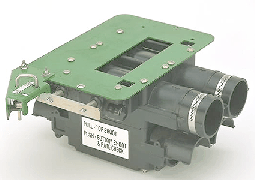 Stationary double-shoot primary manifold
Stationary double-shoot primary manifold

Primary manifolds are mounted below the tanks with 63.5-mm (2-1/2-in.) diameter tubes to distribute seed/fertilizer evenly to the secondary manifolds, which are located on the seeding tool.
63.5-mm (2-1/2-in.) primary lines are clear with either a black or green spiral:
-
Black spiral for single-shoot systems
-
Black and green spiral for double-shoot systems
Stationary single-shoot or stationary double-shoot primary manifolds are available.
Single-shoot air systems are used when seeding only or when applying a starter fertilizer along with the seed. Double-shoot air systems are used when applying higher levels of fertilizer, allowing simultaneous application of seed and fertilizer by placing them in two different locations in the seed row. With the proper 1910 Cart configuration, starter fertilizer can also be applied with the seed in a double-shoot air system.
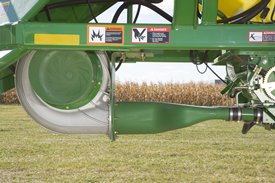 High-output, hydraulically driven fan
High-output, hydraulically driven fan
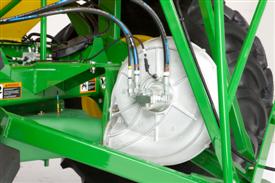 Fan as seen on 19,400-L (550-bu) cart
Fan as seen on 19,400-L (550-bu) cart
The 1910 Commodity Air Cart uses an airstream to gently deliver seed and/or fertilizer to the openers. A strong, consistent airstream is necessary to keep product moving without plugging the air runs, while making sure damage is not occurring to the seed.
The large 450-mm (17.6-in.) diameter fan generates a low-velocity, high-volume airstream that carries the product to the openers. By using a high volume of air, there is less chance of damaging seed, while decreasing the likelihood of plugging the air system.
The fan is driven by the tractor's hydraulic system. It requires approximately 53- to 75-L/min (14 to 26-gpm) oil flow for operation.
IMPORTANT: The 53- to 75-L/min (14- to 26-gpm) is for the 1910 Cart fan only; additional hydraulic capacity from the tractor is also required for the hydraulic drive motors and for the seeding tool, depending on what seeding tool is chosen.
NOTE: Requires motor seal drain kit.
Hydraulic drives provide accurate metering and variable rate
Hydraulic drives
Starting in model year 2014, hydraulic drives became standard equipment on the 1910 air carts, offering consistent drive power to the meters. Hydraulic drives come standard with variable-rate drive and hydraulic calibration.
The drive system reduces a large number of mechanical and electrical components including transmissions, clutches, chain drives, sprockets, gears, and shafts by replacing them with a hydraulic drive motor, electrohydraulic valve, and a chain drive connecting the motor and meter.
Each meter has its own hydraulic drive motor and can be set independently of each other. It is recommended to use power beyond or another selective control valve (SCV) if power beyond is not available. Hydraulically powered meters minimize the pulsing effect found in chain driven systems. The motor speed is controlled by an electrohydraulic valve mounted on the motor.
Operators can shut off any meter from the in-cab display. The cart software comes with six pre-loaded rates for seeding. Map based prescriptions can be used with variable rates.
The system uses wheel speed from the cart to determine ground speed. If the cart wheel speed drops below 3.2 km/h (2 mph), the system will use tractor speed, if available, to maintain proper application rates when turning or coming out of a headland turn.
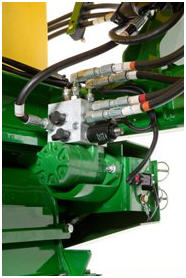 Hydraulic drive motor
Hydraulic drive motor

Variable rate
Starting in model year 2014, hydraulic variable-rate drive became standard equipment for 1910 air carts. Quick changing rates are important for maintaining accuracy with variable-rate prescription applications.
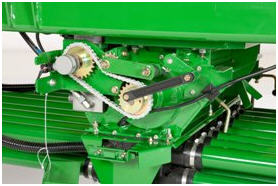 Meter drive system
Meter drive system
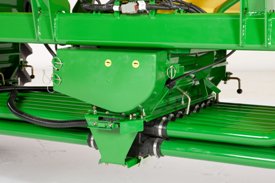 Meter drive system with safety shield installed
Meter drive system with safety shield installed
Hydraulic calibration
Hydraulic calibration makes it convenient to rotate the cart meters to perform accurate calibration.
More than one meter can be calibrated at a time. Following the below instructions for 1910 air carts:
- Weigh bag, tare scale
- Add bag to bottom of meter
- Rotate the meters twice to charge them with product
- Turn the meters until they stop
- Weigh the bag with product inside
- Enter the weight of the product on the in-cab display
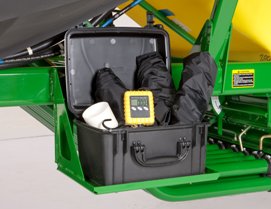 Calibration tools and equipment
Calibration tools and equipment
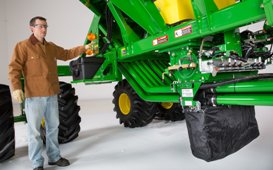 Operator performing calibration
Operator performing calibration
Meter verification
Operators can perform meter verification without driving. In the meter verification page on the in-cab display, select the meter(s) to verify and the stationary checkbox. When the operator engages the calibration switch, the meter will turn the number of revolutions to meter out the amount of product for the area selected.
NOTE: It is highly recommended to have power beyond and load sense installed on the tractor hydraulic system to power the hydraulic drives. This feature will save fuel, as well as reduce hydraulic heat, while providing maximum performance by the tractor hydraulic system to the cart hydraulic drive motors. By having load sense, the tractor is only required to provide the pressure and flow that the drives require. Power beyond and load sense capability have been tested and approved for all 8x00, 9x00, and newer John Deere tractors. Older John Deere tractors and competitive tractors have not been tested for functionality. If power beyond is not available, an additional SCV will be needed to power hydraulic drives. See link for more information on power beyond kits.
NOTE: Hydraulic drives cannot be performance upgraded onto mechanical drive carts.
NOTE: For high application rates, it is recommended to utilize tractors with the hi-flow hydraulic pump option. See 1910 Commodity Cart tractor compatibility and requirements for more information.
SectionCommand™ system saves seed and fertilizer input costs
SectionCommand controls seed and fertilizer overlaps and skips
Controlling input costs and improving productivity are key producer requirements today. SectionCommand is an effective, integrated John Deere solution designed to meet these intensifying needs. SectionCommand manages both seed and fertilizer application by minimizing overlaps and skips while seeding with the John Deere 1910 and C850 Air Carts.
Owner benefits include:
- Improved consistency of crop maturity at harvest
- Improved consistency during emergence and growing season
- Reduced seed input cost
- Reduced fertilizer input cost
- Increased time between fills due to input savings
SectionCommand is base equipment with optional deduct on all John Deere 1910 and C850 Air Carts. Each tank and meter will receive SectionCommand components. A two-tank cart will control sections out of both tanks, a three-tank cart will control sections out of all three tanks, and the C850 cart will control sections out of all four tanks. SectionCommand is also available as an attachment for field conversion (AFC) for all 1910 hydraulic drive carts. See AFC kit story for more information.
SectionCommand controls seed and fertilizer output by closing and opening gates on the bottom side of the meter. When the gates are open, commodity is metered out, and when closed, commodity stays and continues to rotate within the meter. The meter stays full at all times so immediately when the gate opens, the commodity can flow into the primaries and out to the tool. Since each meter section has its own gate, application rates and row-to-row accuracy are not compromised. The gates are utilized to control commodity output on all sections. Once the last gate needs closed, the entire meter will stop turning, stopping product flow.
 Seeded fields photo
Seeded fields photo

When commanded, electric over-hydraulic solenoids engage actuators to instantaneously close the gate for the needed section. The actuators are powered via hydraulics from the same circuit as the hydraulic drive motors. When power is cut, oil is diverted to retract the actuators and open the gates. The retraction is both powered and spring assisted, so it will always default to the seeding position. The oil from SectionCommand drains back through the fan motor case drain line and is coupled with an accumulator on the valve block to provide extra drainage capacity.
 SectionCommand components as seen on back side of meter
SectionCommand components as seen on back side of meter
 SectionCommand components as seen on front side of meter
SectionCommand components as seen on front side of meter
SectionCommand incorporates gate detection, which gives producers the satisfaction of knowing the gates are in position as commanded. Magnets on the back side of the gates are used in close proximity to the gate detection sensors to determine if the gates are open or closed. Should a gate not be in the commanded position, an alarm will alert the operator of the gate(s) in question. The blockage warning system works in conjunction with SectionCommand to give further confidence whether a given section is seeding or not when commanded.
 SectionCommand meter cartridge showing one gate closed and magnet on backside of gate
SectionCommand meter cartridge showing one gate closed and magnet on backside of gate
 Gate detection sensor
Gate detection sensor
For maximum performance, SectionCommand should be controlled through John Deere Section Control. Coupling SectionCommand with John Deere Section Control provides the ultimate in precision seeding and productivity. If a Section Control activation is held by the producer, that same activation can be utilized for SectionCommand.
SectionCommand introduces the orange roller, which has the same number of flutes and spacing as the blue roller, but shorter flutes. It is for use only with SectionCommand when seeding seeds larger than 6 mm (0.25 in.) in diameter (soybeans, chick peas, etc.). The orange roller is not for use with cereal grains or fertilizer.
 Orange roller, for use only with large seeds and SectionCommand
Orange roller, for use only with large seeds and SectionCommand
SectionCommand equalizer
Due to the varying lengths of product delivery hose used across the drill, SectionCommand has a built in equalizer feature to ensure consistent product delivery across the width of the drill when entering and exiting headlands. The software allows the producer to set the on/off product delivery times separately for the outermost opener and the innermost opener on the drill. Product delivery times are inputted for each tank on the cart, and the software creates a time delay for actuation of the gates.
Please see the Using SectionCommand video for more information.
 Enabling SectionCommand equalizer
Enabling SectionCommand equalizer
 Input on/off times for outer opener versus inner opener on each tank
Input on/off times for outer opener versus inner opener on each tank
NOTE: Please reference CCMS solution 111434 for more information.
Wirelessly controlled hydraulic conveyance reduces operator physical effort
Operators continually seek easier and faster operations while seeding and reduce time spent filling and unloading.
Conveyance on 12,334-L (350-bu), 15,200-L (430-bu), and 19,400 (550-bu) carts is controlled by hydraulic cylinders on the conveyance arms. The cylinders move the main arm, swing arm, and elevation. Now operators can easily deploy the conveyance system with less effort.
Input to the system is received from one of two remotes. Each operator receives a wireless remote that can be operated from anywhere near the cart and a tethered remote that can be operated from ground level near the front meter. Each remote controls the same functions and gives flexibility of system control should two operators be in the area during cart fill and unload.
The remotes can start, stop, and control speed of the conveyance system. For added security, the speed control arm is retained on the conveyance and can override the remotes to slow down or stop the belt or auger.
Securing the auger or conveyor is now easier and gives the operator a greater sense of security with over-center latches on both the top and bottom of the conveyance.
Both the main and swing arms are longer giving operators greater flexibility in tendering vehicle parking locations.
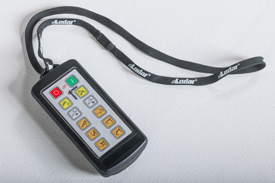 Wireless remote
Wireless remote
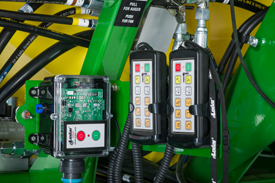 Receiver and tethered remote
Receiver and tethered remote

A - Remote on/off
B - Conveyance stop/start
C - Conveyance slow down/speed up
D - Tilt/elevation
E - Main arm retract/extend
F - Swing arm retract/extend
 Factory-installed hopper
Factory-installed hopper
 Left-hand side of cart in transport
Left-hand side of cart in transport
 Left-hand side of cart in fill position
Left-hand side of cart in fill position
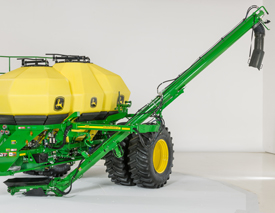 Left-hand side of cart in unload position
Left-hand side of cart in unload position
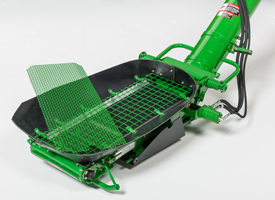 Low-profile hopper folder and unfolded
Low-profile hopper folder and unfolded
 Low-profile hopper folder and unfolded
Low-profile hopper folder and unfolded
Low-profile hopper
For operators who fill carts from semi hopper bottoms or who desire full width meter clean out, John Deere has partnered with KSi® Conveyors to provide a low-profile hopper. The hoppers are compatible with all hydraulic conveyance carts. The hoppers utilize conveyor belts and are available for both the 254-mm (10-in.) auger and 305-mm (12-in.) conveyor. The hoppers are longer than competitive offerings on similar cart sizes.
The hoppers easily fold over to keep mud and rocks from being slung into the hopper and for tight maneuverability during transport and seeding. During fill and unload, flip the hoppers back over to move product.
Each hopper comes with both a large and small screen for optimizing product flow and catching foreign material during fills. Rubber skirting around the hopper provides flexibility during use and adds capacity to the hopper.
Please contact KSi Conveyors for ordering information.
KSi Conveyors Inc.
c/o Bruce Frank
1(888) 574-3277
+1(815) 457-2403
jddealer@ksiconveyors.com
http://www.ksiconveyors.com/jddealer
KSi is a trademark of KSi Conveyor, Inc.
SectionCommand™ system field conversion kit
SectionCommand is available as an attachment for field conversion (AFC) for all hydraulic drive carts. See SectionCommand saves seed and fertilizer input costs for more information on benefits and workings of the system.
 SectionCommand components on 1910 Cart with meter cartridge removed
SectionCommand components on 1910 Cart with meter cartridge removed
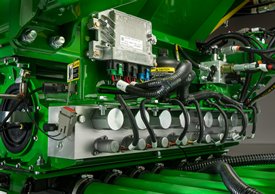 SectionCommand on 1910 Air Cart
SectionCommand on 1910 Air Cart
There are four main components needed to add SectionCommand onto 1910 hydraulic drive air carts:
1. SectionCommand AFC kit (listed in the table below, order one kit per meter), kit includes:
- SectionCommand valve block and meter housing components
- Gate detection controller
- Electronic power module (EPM)
- Associated harnessing, hardware, and brackets
2. Hydraulic hoses - Dealer is responsible for fabricating and sourcing hoses.
3. SectionCommand meter cartridges will be needed for each meter. These meter cartridges contain gates, gate detection sensors, and a secondary meter lock-down. See Meter cartridges for field conversion for more information.
4. New Operator’s Manual including SectionCommand. Order A98462 or newer 1910 operator’s manual when installing onto a model year 2013 19,400-L (550-bu) cart or all model year 2014 carts.
Ensure the latest version of software is installed on both cart controller and in-cab display.
All SectionCommand kits are sold in eight-run configurations. If pairing the cart with a tool of seven runs or less, order one - BA32812 meter run reduction kit per cart. This kit contains parts to block off runs not used when pairing a cart with a tool of seven runs or less.
NOTE: For SectionCommand to operate properly, it must be installed on each meter.
SectionCommand™ savings calculator assists operators in determining potential savings
To assist in determining savings potential for an operation when using SectionCommand, please utilize the savings calculator. A link is provided for access to the calculator.
Directions:
The savings calculator can calculate savings potential for up to three crops. Insert the variables into the yellow boxes for each of the three crops. Input variables include:
- Crop(s)
- Acres of each crop
- Seeding rate per acre
- Seed price per pound
- Fertilizing rate per acre
- Fertilizing rate per pound
Green boxes will list the potential savings per crop and total savings are listed at the bottom of the page.
1910 Cart brakes
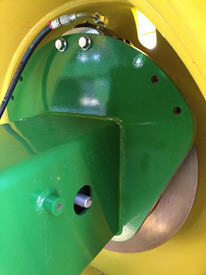 1910 Cart brakes
1910 Cart brakes
Cart brakes are an option with 430 Tow Between, 430 Tow Behind, and 550 Tow Behind carts. The brakes are required when using a 18.3-m (60-ft) N560F Disk Drill or 23.2-m (76-ft) P576 Air Hoe Drill.
The air cart hydraulic brakes connect to the tractor’s hydraulics through a brake connection at the rear of the tractor. Tow behind carts require an extension hose for the air seeding tool.
The air cart brake system supplements the tractor brakes. The cart system senses when the tractor’s brakes are applied and engages a caliper on a rotor at each rear axle hub.
Ensure the tractor has a hydraulic brake port and is equipped with adequate ballast for the air cart and seeding tool.
Air Power™ 2 fan drive system
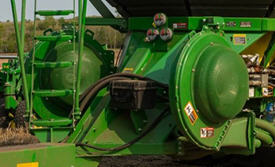 Air Power 2 fan drive system
Air Power 2 fan drive system
Enhanced air seeding performance would not be possible without the updates to the 15,152-L (430-bu) and 19,381-L (550-bu) 1910 and C850 air carts.
For the wider seeding width, more fan capacity has been added.
Air Power 2 provides two independently controlled fans – one for seed, one for fertilizer. Along with 76.2-mm (3-in.) primaries, more accurate delivery rates are possible across the full width of the seeding tool – from opener to opener. Air Power 2 delivers high rates, up to 40 percent more product delivery per primary compared to the single-fan system.
Dual fans are required for tow-between and tow-behind carts on the 23.2-m (76-ft) P576 and the 18.3-m (60-ft) N560F. Each fan will direct air to one set of primaries. Two selective control valves (SCVs) are required for the fans. The fan speed will be controlled through the SCV flow control.
Air Power 2 will also be compatible with:
- 17-m (56-ft) P556
- 13-m (43-ft) N543F
- 15.2- and 18.3-m (50- and 60-ft) 1890 models
An option is available for stainless-steel primaries to resist corrosion from high fertilizer rates.
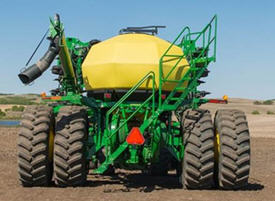 C850 Air Cart
C850 Air Cart
There is a slide at the meter to choose bottom or top shoot for each product. There is also a valve on the tank pressure system to choose top or bottom shoot. This same valve is used to adjust the amount of air to the tank to create the proper pressure differential.
 Pressure valve handle
Pressure valve handle
The arrow on the valve handle should be pointing to the top of the range for the top shoot and the bottom of the range for the bottom shoot. If the tank will not be in use, set the pressure valve to the middle setting to not pressurize the tank. The operator should use the gauge to find the correct setting. Location of pressure read-out:
- 1910 Tow-Behind left-hand side of cart on pressure gauge*
- 1910 Tow-Between front of the cart on pressure gauge*
- C850 Air Cart side display
* The electronic pressure sensor is located behind the mechanical gauge on the side of the cart.
For all Air Power 2 configured carts, an electronic pressure sensor will send a warning to the display if the tank pressure differential is out of range. If pressure is in the green operating range, the tanks are sealed and operating correctly.
Tank warnings on the GreenStar™ 3 2630 Display
NOTE: Only applies to 1910 AirPower 2 Carts as the C850 Cart is only compatible with the Gen 4 4600 CommandCenter™ or 4640 Universal Display.
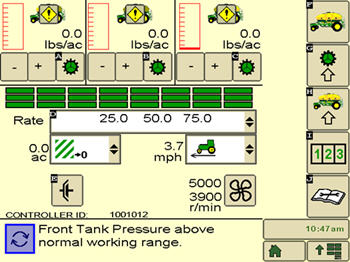 Tank warning on display
Tank warning on display
The operator will receive a warning in the display if a tank’s pressure is above or below normal working range. There will be a warning sign over the tank with the out-of-range issue.
Select the icon to view the tank pressure screen.
 Tank pressure screen – plus indicates too much product
Tank pressure screen – plus indicates too much product
The operator can press on the red warning and get a screen that looks like the picture above. The plus indicates the pressure is out of range and could be delivering too much product.
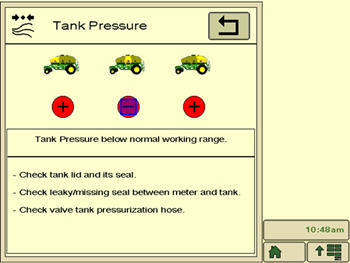 Tank pressure screen – minus indicate too little product
Tank pressure screen – minus indicate too little product
The minus indicates the pressure is out of range and could be delivering too little product.
*Only applies to 1910 Air Power 2 Carts as the C850 Cart is only compatible with the Gen 4 4600 CommandCenter™ or 4640 Universal Display.
NOTE: A quick reference guide will ship with every operator’s manual. Please reference that and the operator’s manual for more detailed information.
Camera ready
Monitoring the product levels in tanks has never been easier with the camera-ready feature of the 1910 and C850 Air Carts. The carts come pre-wired to accept a camera in each tank and on the rear of the machine. Cameras allow the operator to conveniently monitor product levels in each tank, which is especially reassuring when product levels are low. Cameras also provide the operator with visibility behind the cart when traveling down the road.
 Camera locations on the 1910 Air Cart
Camera locations on the 1910 Air Cart

 Camera location on the C850 Air Cart
Camera location on the C850 Air Cart
For the 1910 Air Carts, the producer has the choice of linking up to three cameras (CabCAM™ or Voyager® cameras) to a GreenStar™ 3 2630 Display or up to four Voyager cameras on a Generation 4 4600 CommandCenter™ Display or 4640 Universal Display. If the producer wants to view more than four cameras, a producer-purchased camera display will be needed.
For C850 Air Carts, the producer can use up to four Voyager cameras on a Generation 4 4600 CommandCenter Display or 4640 Universal Display. If the producer wants to view more than four cameras, a producer-purchased camera display will be needed.
NOTE: Generation 4 displays only support Voyager cameras.
While the 1910 and C850 Air Carts come pre-wired to adapt cameras, additional harnesses are necessary for connecting to the tractor, and a tool overlay harness will be needed for tow-behind carts. Please use the option codes below if ordering on a new machine or the part numbers for configuring an existing machine.
Option code |
Description |
Parts |
9610 |
Tool overlay harness |
AA94564 |
9615 |
Gen 4 4600 CommandCenter Display tractor cab harness |
AA93727 (order one per camera) AA94316 |
9620 |
4640 Universal Display tractor cab harness |
SWTY268456 AA94316 |
9625 |
GreenStar 3 2630 Display tractor cab harness | AA94319 AA94316 |
Some carts may require SWVOSCCAM and AA96311, a Voyager connector to CabCAM connector, on the rear of the cart.
CabCAM is a trademark of ATI Products, Inc. Voyager is a trademark of ASA Electronics, LLC.
Features
Electronic population rate control saves seed costs
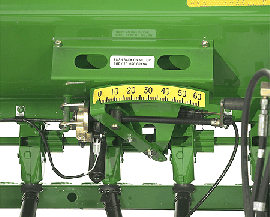 Electronic population rate control
Electronic population rate control

With seed prices on the rise, producers want the ability to monitor and control seed populations on the go.
Electronic population rate control (EPRC), in base equipment on the 1590 Drill, allows producers to adjust the population rate right from the convenience of their tractor cab.
The system:
- Features an in-cab rocker switch to adjust the electric motor that controls the population rate
- Is manually adjusted – the operator must hold down the adjustment switch until the desired rate is met
- Can be overridden by pushing back on the motor to allow the producer to make a manual adjustment to the rate if needed
NOTE: To give producers the ability to monitor the population rate on the go, it is highly recommended they equip the unit with a ComputerTrak™ monitor or SeedStar™ population monitoring.
NOTE: One system is used with 3.05-m (10-ft) and 4.6-m (15-ft) drills. The 6.1-m (20-ft) models require two systems.
Productive seedbox capacities
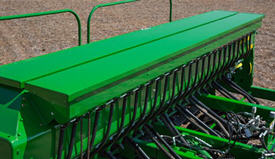 Seedbox
Seedbox
Seedboxes have large capacity for longer intervals between stops for refilling.
Plain grain or combination grain/fertilizer seedboxes are available to match the producer's needs and crops.
The versatile grain/fertilizer box with 19-mm (7.5-in.) row spacing can be set for 100 percent grain or 60 percent grain/40 percent fertilizer.
The bulkheads in the seedbox reduce material shifting in the box for increased seeding efficiency.
The sight glass located near the end of the box on combination grain fertilizer drills allows the operator to view seed level at a glance.
Seedbox capacities |
|||
| Plain grain | Combination grain/fertilizer |
||
100 percent grain |
60 percent grain/40 percent fertilizer |
||
| Grain, bu/ft (L/m) | 3.5 (405) |
3.5 (405) |
2.1 (243) |
| Fertilizer, bu/ft (L/m) | --- |
--- |
1.4 (162) |
| Total, bu/ft (L/m) | 3.5 (405) |
3.5 (405) |
3.5 (405) |
| Plain grain box | Combination box | |
| Total box - 3.05 m (10 ft) | 1233.4 L (35 bu) | 1317.9 L (37.4 bu) |
| Total box - 4.6 m (15 ft) | 1850.1 L (52.5 bu) | 2026.2 L (57.5 bu) |
| Total box - 6.1 m (20 ft) | 2466.7 L (70 bu) | 2635.9 L (74.8 bu) |
Capacities with grass seed attachment
| 3.05 m (10 ft) | 4.6 m (15 ft) | 6.1 m (20 ft) | |
| Grass seed box with plain grain box | 105.7 L (3 bu) | 169.1 L (4.8) | 211.4 L (6 bu) |
| Grass seed box with combination box | 52.9 L (1.5 bu) | 84.6 L (2.4 bu) | 105.7 L (3 bu) |
1590 Drill seed/fertilizer delivery system
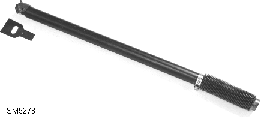 Seed tube
Seed tube
A long, internally smooth seed tube with a molded elbow is supported at the seed tube support. From there, it is connected to a short convoluted seed tube, allowing product to flow smoothly to the openers and still flex.
The tube flexes to avoid crimping for consistent seed flow. It is made of non-corrosive nylon material for long life. Long tubes are 55.4 cm (21.8 in.) and short tubes are 10.8 cm (4.25 in.).
Elbow at meters to angle the seed tube directly to the openers.
The smooth inside diameter provides smooth seed flow from the meters to the furrow openers.
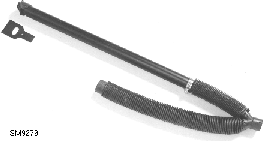 Seed tube with Y-adapter
Seed tube with Y-adapter
The combination grain/fertilizer drill with 19-cm (7.5-in.) row spacing features a convoluted tube directing fertilizer from the discharge hole to the top of the steel seed tube at the seed boot. From there, a special Y-adapter lets seed and fertilizer mix before going into the furrow.
Proven no-till openers provide excellent penetration with rugged durability
 Seed placement with ProSeries™ Opener
Seed placement with ProSeries™ Opener
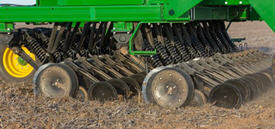 1590 Series down pressure
1590 Series down pressure
ProSeries single-disk no-till openers are included in base equipment. The single-disk openers are mounted on one rank on the 38.1-cm (15-in.) row spacing single rank units and on two ranks on the 19-cm (7.5-in.) and 25.4-cm (10-in.) row-spacing units. The single-disk openers provide consistent and accurate seed placement.
The single-disk openers are gang mounted and are hydraulically raised and lowered. The hydraulics also work to provide a wide range of downforce settings for the openers.
The active hydraulics work in conjunction with the opener spring to provide an adjustable range of 74.8 kg to 181.4 kg (165 lb to 400 lb) of down pressure per opener to penetrate hard soils and heavy residue.
The down pressure is easily adjusted with the pressure valve located on the front of the mainframe, giving the operator the ability to quickly adjust, or dial in, the down pressure as operating conditions change.
For additional ballast in hard-to-penetrate conditions, tractor suitcase weights may also be added to obtain maximum down pressure per opener. On the 3.05-m (10-ft) and 4.6-m (15-ft) machines, up to 10 weights can be added. On 6.1-m (20-ft) machines, up to 20 weights can be added (10 per side).
The no-till openers work not only in no-till conditions, but also in clean-till conditions. There are 5.1 cm (2 in.) of free travel in the opener before spring down pressure takes over, allowing the opener to move over individual rocks and minimizing the chance of the gauge wheels bulldozing soil in soft or mellow conditions.
Secondly, the opener spring will then travel a maximum of 20.3 cm (8 in.) up or 15.2 cm (6 in.) down before the hydraulics react to uneven seedbeds.
Lastly, the cylinders will allow the openers to travel up or down an additional 40.6 cm (16 in.) with active hydraulic down pressure to follow the ground. The hydraulics will give the openers additional pressure when needed or allow the openers to go into relief if the pressure becomes too high.
Features
Productive seedbox capacities
 Seedbox
Seedbox
Seedboxes have a large capacity for longer intervals between stops for refilling.
| Drill | Total box capacity | L/m (bu/ft) |
| 4.6-m (15-ft) model | 1480 L (42 bu) | 321.7 L/m (2.8 bu/ft) |
| 6.1-m (20-ft) model | 1409.6 L (40 bu) | 231.1 L/m (2.0 bu/ft) |
All boxes are plain grain with a large, single lid for accessing the seedbox.
Double-disk furrow openers
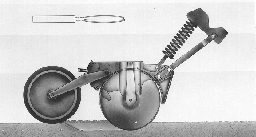 Double-disk opener
Double-disk opener
 Double-disk opener
Double-disk opener
Double-disk openers create a furrow in which seed is placed. They work best in a prepared seedbed and leave the field relatively smooth, with minimal soil throw.
The double-disk openers are available with 152.4-mm, 190.5-mm, and 254-mm (6-in., 7.5-in., and 10-in.) row spacings. The 152.4-mm (6-in.) spaced drills have nominal residue flow in minimum till conditions. The 190.5-mm (7.5-in.) spacing is recommended for wet, sticky soil conditions such as the Red River Valley.
Cast-aluminum boots are standard equipment. Openers come with a zigzag pattern, with alternate short and long drawbars, to provide good trash flow in varied field conditions. The alternating of blades with a right/left leading-edge offset improves penetration.
Blades are offset with a 6.35-mm (1/4-in.) leading edge, and the pinch point is close to where the blades meet the soil for better penetration and residue cutting.
Features
Seedbox capacities
 Seedbox
Seedbox
 Three-position combination grain/fertilizer box
Three-position combination grain/fertilizer box
Seed boxes have a large capacity for longer intervals between stops for refilling.
Plain grain or combination grain/fertilizer seed boxes are available to match the producer's needs.
The versatile grain/fertilizer box has a three-position divider that can be set for 100 percent grain, 60 percent grain, or 40 percent grain.
| Seedbox capacities | ||||
| Plain grain | Combination grain/fertilizer Three-position divider |
|||
| 100 percent grain | 60 percent grain | 40 percent grain | ||
| Grain, L/m (bu/ft) | 324 (2.8) | 320 (2.76) | 168 (1.82) | 152 (1.35) |
| Fertilizer, kg/m (lb/ft) | --- | --- | 168 (113) | 226 (152) |
| Total, L/m (bu/ft) | 324 (2.8) | 320 (2.76) | 3.4 (393) | 3.4 (393) |
- The bulkheads in the seedbox reduce material shifting in the box for increased seeding efficiency.
- A sight glass, located near the end of the box, allows the operator to view seed level at a glance.
- Steel footboards with 25.4-mm (1-in.) diameter perforations allow convenient, safe access to the seed/fertilizer boxes.
- In-line box design allows quick and easy filling.
A grass seeder attachment is available (see attachments in the Ag Sales Manual). The grass seeder attaches to the front of the seedbox and is commonly used for grasses and alfalfa.
Tank shield plates are available from Parts (see attachment for field conversion),
- Protects box-end panels from damage
- Ideal for operating in very irregular terrain, where box panels could contact each other
Front-folding frame allows for narrow transport
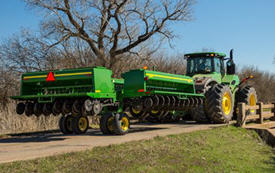 Narrow road transport
Narrow road transport

A fully hydraulic front fold/unfold system makes folding on the 455 Drills, for transport a true one-person operation.
- Requires less than 5 minutes to fold or unfold
- Transport width is narrow as 4.6 m (15 ft, 2 in.)
High opener transport clearance allows moving over ditches, railroad crossings, and other trouble spots without worry.
Opener to road clearance:
- 533.4-mm (21-in.) on 9.15-m (30-ft) and 10.7-m (35-ft) models
- 457.2-mm (18-in.) on 7.6-m (25-ft) model
Units are raised and lowered for transport with standard equipment-lift cylinders:
- Two 76.2-mm x 203.2-mm (3-in. x 8-in.) cylinders on 7.6-m (25-ft) drill
- Two 88.9-mm x 254-mm (3.5-in. x 10-in.) cylinders on 9.15-m (30-ft) and 10.7-m (35-ft) drills
There are four frame-mounted tires: 11L-15, 10 PR rib implement on all three drill sizes.
Warning lights are in base equipment for improved visibility when transporting.
Features
Spoked gauge wheels


Growers have historically had to make some difficult planting and seeding decisions due to weather. Operators have been forced to plant in wet conditions that are far from optimal in order to plant within the optimum planting window. Those operators have experienced poor performance from wet soils working in between the depth gauge wheel and the opener disk and not having a way out. This creates the possibility of the depth gauge wheel or opener disk to seize up and drag through the soil.
The spoke gauge wheel is a solution for operators who plant in these conditions to allow the mud and debris that get caught behind the depth gauge wheel to easily flow through the wheel and continue providing superior depth performance.
The spoke gauge wheel is designed for optimum performance. Its features include serviceable, stamped inner and outer rims. The wheel also has cast spokes and bearing hubs for increased strength. This allows smaller spokes, creating larger open surface area for mud and debris to flow more easily than competitor’s wheels. Another improvement over the closed gauge wheel is a snap-ring bearing retention. Simply remove the snap ring, replace the bearing, and place the snap ring back.
 Gauge wheel
Gauge wheel
 Gauge wheel
Gauge wheel
Heavy trash fields from no-till environments have also tested very well with the new spoke gauge wheel. Some growers provided feedback of crop residue getting inside and jamming up the gauge wheel and opener. This spoke gauge wheel has shown exceptional performance within these areas as well. These wheels are compatible with both 90 Series openers on seeding tools and planter row-units.
Below is a chart that demonstrates a competitive advantage over MudSmith™ wheels for mud and residue flow:
| MudSmith | John Deere | Percent improvement | |
| Open area | 329 cm2 (51 cu in.) | 471 cm2 (73 cu in.) | 43 percent |
| Rim height | 1.9 cm (3/4 in.) | 1.4 cm (9/16 in.) | 25 percent |
| Spoke width | 3.5 cm (1-3/8 in.) | 1.9 cm (3/4 in.) | 45 percent |
The wheel is serviceable along with other parts.
- AA86055 – complete wheel assembly
- A101570 – inner wheel rim half
- A101571 – outer wheel rim half
Not compatible in dual gauge wheel applications.
MudSmith is a trademark of MudSmith, LLC.
Air Power™ 2 fan system and compatibility
 Air Power 2 fan system
Air Power 2 fan system
Enhanced air seeding performance would not be possible without the updates to the 15,152.8-L (430-bu) and 19,381.5-L (550-bu) 1910 and C850 Air Carts. For the wider seeding width, more fan capacity has been added.
Air Power 2 provides two independently controlled fans – one for seed and one for fertilizer. Along with large, 76.2-mm (3-in.) primaries, more accurate delivery rates are possible across the full width of the seeding tool, from opener to opener. Plus, Air Power 2 allows growers to deliver high rates under field operating conditions – up to 40 percent more product delivery per primary compared to the single-fan system.
Dual fans are required for tow-between and tow-behind carts on the 23.2-m (76-ft) 1870 and 18.3-m (60-ft) 1895 models along with the eight primaries. Each fan will direct air to one set of primaries. Two selective control valves (SCVs) are required for the fans. The fan speed will be controlled through the SCV flow control.
Air Power 2 will also be compatible with the current 17.1-m (56-ft) and 23.2m (76-ft) 1870 Air Hoe Drills, as well as the 13.1-m (43-ft) and 18.3-m (60-ft) 1895 Disk Drills, plus the 15.2-m (50-ft) and 18.3-m (60-ft) 1890 models. An option is available for stainless-steel primaries to resist corrosion from high fertilizer rates.
 C850 Air Cart
C850 Air Cart
There is a slide at the meter to choose bottom or top shoot for each meter. There is also a valve on the tank pressure system to choose top or bottom shoot. This same valve is used to adjust the amount of air to the tank to create the proper pressure differential.
 Tank pressure valve
Tank pressure valve
The arrow on the valve handle should be pointing to the top of the range for the top shoot and the bottom of the range for the bottom shoot. If the tank will not be in use, set the pressure valve to the middle setting to not pressurize the tank. The operator should use the gauge to find the correct setting. An electronic pressure sensor will send a warning to the display if the tank pressure differential is out of range.
If pressure is in the green operating range, the tanks are sealed and operating correctly. The electronic pressure sensor is located behind the mechanical gauge on the side of the cart.
RelativeFlow™ Blockage sensing
 RelativeFlow blockage sensing
RelativeFlow blockage sensing
With the RelativeFlow blockage system, operators can see the flow rate of both seed and fertilizer from inside the tractor cab. Sensors on delivery hoses monitor the relative rate of product flow. An easy-to-read display clearly visualizes relative product flow across the drill, from opener to opener. This exclusive technology gives a better view of what is happening across the tool in order to spot problems before blockage occurs.
RelativeFlow Blockage is available on the following models:
- 1890 - 15.2-m (50-ft) and 18.3-m (60-ft)
- 1870 - 12.2-m (40-ft), 17.1-m (56-ft), and 23.2-m (76-ft)
- 1895 - 18.3-m (60-ft)
- N500C – all widths
Below are the GreenStar™ 3 2630 Display screens for the blockage monitoring system. For complete details and information, see the owner’s manual.
 Blockage monitoring screen
Blockage monitoring screen
The RelativeFlow system chart shows the amount of flow through each sensor on the selected tower. Sensitivity for the blockage system can be adjusted if desired, as shown below.
 Blockage set-up screen
Blockage set-up screen
Blockage warning sensitivity allows the producer to set and change the sensitivity of the sensors to meet their preferences. Increasing the sensitivity means the system is more likely to show a false blockage, while less sensitivity means the system is more likely to miss a blockage.
Multiple run-page alarm behavior options are available for selection.
 Blockage set-up screen
Blockage set-up screen
Below are the Gen 4 display screens for the blockage monitoring system on the N500C.
For complete details and information reference, the owner’s manual.
 RelativeFlow Blockage configured run page
RelativeFlow Blockage configured run page
The SeedStar™ system run page displays the five major run settings. Clicking on any of the tiles will take an operator to that specific page (shown below).
 Operators can zoom into flow details by meter section when selecting Blockage tiles
Operators can zoom into flow details by meter section when selecting Blockage tiles
 Operators can zoom into the row level to access row/sensor information and turn a sensor on/off independently
Operators can zoom into the row level to access row/sensor information and turn a sensor on/off independently
 Blockage sensitivities and alarm delays are all set up on one easy-to-navigate screen
Blockage sensitivities and alarm delays are all set up on one easy-to-navigate screen
Blockage alarm delays can be set up by clicking on the advanced settings button from the blockage set-up screen.
- A blockage delay is how long a blockage should occur before an alarm is sounded.
- The blockage alarm reminder is how often the alarm should sound when a blockage occurs.
- The meter on delay is the time from when the meter is turned on until the blockage sensor should start monitoring for blockage.
- The meter off delay is the time from when the meter is turned off until the blockage sensor should start monitoring to verify no flow.
For more detailed information, see the owner’s manual.
TruSet™ system downforce control
 Downforce control from the cab
Downforce control from the cab
TruSet downforce control enables operators to conveniently set values for the seed and fertilizer ranks independently from the cab. This feature enables them to meet optimal downforce pressure while in varying soil conditions. TruSet downforce control improves seed placement accuracy in varying field conditions, leading to improved emergence and plant maturity.
TruSet system quick-reference guide

TruSet system quick-reference guide image key:
- Select here to choose from a list of programmed downforce setpoints.
- Select here to enter calibration screens, input downforce setpoints, and to verify the tractor selective control vavle (SCV) controlled by automation.
- TruSet – main menu button
- TruSet Run Screen
- Setup – select to configure tool
- Warning Setup – select to set downforce warnings
- Float Mode – select to toggle the float mode on and off. This option is only available using Power Beyond control options.
- Diagnostics – select to enter diagnostic information
- Press the plus or minus button to increase or decrease the downforce.
- Enter a value here to increase or decrease the downforce.
- Enables the downforce system
- Disables the downforce system
TruSet system tool setup
 Tool setup
Tool setup
Select the tool setup to enter calibration screens, input downforce setpoints, and to verify the tractor SCV controlled by automation:
- Enter target setpoint for downforce
- Enable pick 6 prescription
TruSet system tool setup - automated SCV

TruSet system tool setup - automated SCV image key:
- This is the time that the SCV remains on to ensure that Power Beyond activates.
- Select SCV configuration
- Enable or disable continuous SCV time
- Select opener control SCV (SCV1-6)
- Select opener control (SCV with Power Beyond, SCV only)
TruSet system tool setup - manual SCV

TruSet system tool setup - manual SCV image key:
- Select opener control SCV Manual (---)
- Select SCV configuration
- Enter values for the extend and retract thresholds if necessary
- Select opener control (SCV with Power Beyond, SCV only)
TruSet system tool setup - Implement Detection

TruSet system tool setup - Implement Detection image key:
- Select Implement Detection
- Select tool mode
- Press to save the values
- Select row spacing
- Select nominal tool width
TruSet system tool setup - opener configuration

TruSet system tool setup - opener configuration image key:
- Select opener configuration
- Enable and disable opener control
- Select opener depth setting (1 through 13)
High-floatation tires improve machine performance
 Tires on the 1895 Disk Drill
Tires on the 1895 Disk Drill
The 18.3-m (60-ft) 1895 Disk Drill offers larger mainframe and wing tires with higher floatation, resulting in less overall surface compaction while minimizing emergence issues. All tires on the 18.3-m (60-ft) machine are 207 kPA (30 psi). The mainframe and wing tires are equipped with casters and walking beams to allow for better ground following.
| Model | Width | Mainframe tire size |
Wing tire size | Mainframe tire pressure |
Wing tire pressure |
Tire size | Flat-plate contact surface area |
| 1895 | 18.3 m (60 ft) | 550/45-22.5 | 33x15.5-16.5 | 207 kPa (30 psi) | 207 kPa (30 psi) | 550/45-22.5 | 1929 cm2 (299 in2) |
| 33X15.5-16.5 | 671 cm2 (104 in2) |
 Wing tires
Wing tires
 Mainframe tires
Mainframe tires
Wider working width increases productivity
 Wider width for more productivity
Wider width for more productivity
This 1895 Disk Drill is 18.3-m (60-ft) wide, which means 40 percent more working width over the current 13.1-m (43-ft) model. This gain in working width can save up to nine passes per quarter section during the same amount of time spent in the tractor cab.
An increase in productivity positively contributes to agronomics. Improving a grower’s productivity will increase the likelihood of hitting the seeding window while minimizing the chance for yield declines.
The opportunity for the 18.3-m (60-ft) 1895 model compared to the 13.1-m (43-ft) model is a $1,500 gain in wheat yield and $2,700 gain in canola yield from increased productivity. The productivity gain for the 18.3-m (60-ft) 1895 paired with a C850 Air Cart can save a grower up to nine passes per quarter section. Overall, this drill was designed for productivity and efficiency.
Separate fertilizer placement (SFP) offers growing advantages
 SPF Openers
SPF Openers
Separate fertilizer placement offers nutrient placement at a 5 or 7-degree angle
The 5-degree fertilizer opener:
- Is required for liquid and anhydrous (NH3) fertilizers
- Will also apply dry fertilizer
- Opens a smaller trench than the 7-degree opener
- Is better able to capture anhydrous and liquid fertilizer and seal fertilizers in the soil
Fertilizer tubes
There are four choices of interchangeable fertilizer tubes:
- Dry fertilizer tube to be used with 32-mm (1-1/4-in.) secondary fertilizer hose from the 1910 Cart
- Liquid fertilizer tube (for 13-mm [1/2-in.] i.d. hose)
- IMPORTANT: Using this tube for anhydrous may cause loss of retention
- Dual fertilizer delivery tube – allows for placement of dry or anhydrous. If applying both simultaneously, the operator may need to provide a relief system to relieve air from dry tube for adequate anhydrous retention. Without air relief, the operator will need to adjust air plenum to restrict all airflow to SFP dry tubes when anhydrous is being applied
- Anhydrous tube (for 10-mm [3/8-in.] i.d. hose)
- Liquid or NH3 fertilizer metering/delivery system is not provided by the John Deere Seeding Group
Key features of the SFP opener are:
- 457.2-mm (18-in.) opener blades operate at 5 degrees, resulting in a narrow trench with less soil disturbance
- Fertilizer tubes are interchangeable among dry, liquid, or anhydrous (NH3)
- Closing wheel assembly is closer to the fertilizer delivery tube; provides increased fertilizer retention
- Serrated closing wheels are base equipment on anhydrous openers and optional on liquid and dry openers
- NOTE: Closing wheels are recommended when dry soil conditions are common
- Extended-wear (chrome alloy) fertilizer boots are standard equipment
- Choice of five different gauge wheels
- Depth adjustments in 6-mm (1/4-in.) increments from 13 mm to 89 mm (1/2 in. to 3.5 in.) deep
Opener furrow-closing wheel
The 25-mm x 305-mm (1-in. x 12-in.) cast closing wheel follows the press wheel to close the furrow, placing soil over seed or fertilizer after the press wheel secures the seed in the furrow.
- A double-row ball bearing to reduce wear is located in the arm of the closing wheel
- Mounted parallel to the furrow opener, the closing wheel can be adjusted laterally to allow running on top of the furrow for sandy or mellow soils or to side of the furrow for heavier soils
- Down pressure is adjustable from 11.8 kg to 19.5 kg (26 lb to 43 lb) (no tools and three adjustments)
- A grease fitting in the pivot arm provides free movement for the arm
ProSeries™ Openers provide excellent penetration
 ProSeries Openers
ProSeries Openers
ProSeries Openers are in base equipment on all 1890 and 1895 Separate Fertilizer Placement (SFP), 1990 Central Commodity System (CCS™), and 1590 Air Drills.
On the 1890 models, the single-disk openers are on 190-mm (7.5-in.) or 254-mm (10-in.) row spacing. On 15.25-m (50-ft) and 18.3-m (60-ft) 1890s, the 190-mm/380-mm (7.5-in./15-in.) or 254-mm/508-mm (10-in./20-in.) dual-row spacing feature is in base equipment. The single-disk openers provide consistent and accurate seed placement.
The ProSeries Openers are gang mounted and are hydraulically raised and lowered. The hydraulic downforce system also offers a wide range of downforce settings for the openers.
 Active hydraulic downforce pressure valve
Active hydraulic downforce pressure valve
The active hydraulics:
- Work in conjunction with the opener spring
- Provide an adjustable range of 75 kg (165 lb) to 180 kg (400 lb) of down pressure per opener
- Benefit: penetrate hard soils and heavy residue
- The cylinders allow the openers to travel up or down an additional 405 mm (16 in.) with active hydraulic down pressure to follow the ground
- Provide the openers additional pressure when needed or allow the openers to go into relief if the pressure becomes too high
The down pressure:
- Is easily adjusted with the pressure valve located on the front of the mainframe
- Provides the operator the ability to quickly adjust, or dial in, the down pressure as operating conditions change
NOTE: For additional ballast in hard-to-penetrate conditions, tractor suitcase weights may also be added to the mainframe and wings to obtain maximum down pressure per opener.
The Proseries Openers:
- Work not only in no-till conditions, but also in minimum or reduced-till conditions
- Provide 51 mm (2 in.) of free travel in the opener before spring down pressure takes over
- Benefit: allows the opener to move over uneven ground conditions and minimize the chance of the gauge wheels bulldozing soil in soft or mellow conditions
- The opener spring travels a maximum of 200-mm (8-in.) up or 150-mm (6-in.) down before the hydraulics react to uneven seedbeds
Green on Green Integration
Tractor, cart, and display compatibility

The 18.3-m (60-ft) tool is five sections with 254-mm (10-in.) spacing and is Air Power™ 2 compatible. This larger tool will require a 15,152.8-L (430-bu) tow-between cart, a 15,152.8-L or 19,381.5-L (430-bu or 550 bu) tow-behind cart, or the C850 Air Cart with Air Power 2 dual fan system. Along with this cart compatibility, breaks are required for this configuration due to the weight of the drill and cart vs. the tractor during transport mode. Below are compatible tractor, horsepower, display, and engine specific details.
Cart compatibility
- 1910 Carts equipped with Air Power 2
- 15,152.8-L (430 bu) tow-between cart
- 15,152.8-L (430 bu) tow-behind cart
- 19,381.5-L (550 bu) tow-behind cart
- C850 Air Cart
Along with the added tool size, the 1895 offers a heavy-duty hitch to pull an additional 20,412 kg (45,000 lb), which is the equivalent of two 7570-L (2,000-gal.) NH3 tanks when using a tow-between cart.
Tractor compatibility

- Recommended minimum 425-kW (570-hp) tractor with a 295.3-L/min (78-gpm) high-flow pump
- Follow recommended ballasting guidelines
- Requires a tractor with four selective control valves (SCVs) plus power beyond
- Requires a brake port for 1910 and C850 Air Cart brakes
- Flat ground - seeding less than (2.5 cm (1 in.)
- 425 kW (570 hp)
- Flat ground - seeding greater than 2.5 cm (1 in.)
- 462.3 kW (620 hp)
- Hilly terrain - seeding at any depth
- 462.3 kW (620 hp with tracks - recommended to obtain proper wheel slip)
- Flat ground - seeding less than (2.5 cm (1 in.)
Engine power capabilities

- The seeding tool system must be compatible with the maximum power that the largest Final Tier 4 (FT4) or comparable manufacturer’s tractor can produce.
- FT4 tractors have an advertised engine horsepower of up to rated power level of 462.3 kW (620 hp). Power bulge for short periods of time increase this to 499.6 kW (670 hp).
- Pulling a full 15,152.8-L (430-bu) cart requires about 51.5 kW (69 hp), the 19,381.5-L (550-bu) cart requires about 66.4 kW (89 hp), and the 29,953.2-L (850-bu) cart requires about 96.9 kW (130 hp).
Display compatibility

This larger tool was designed for the Gen 4 CommandCenter™ display. This technology integration saves time and money.
- 4600 CommandCenter™ display with Premium Activation
- 4640 Universal Display with core activation
ProSeries™ Opener retrofit kit
Growers that may be interested in upgrading their current 90 Series Openers to the ProSeries Openers can do this by ordering a ProSeries retrofit kit.
Two kit offerings are available for seed openers, a two row (AA98693) and eight row (AA97392) kit. The breakdowns are as follows:
AA98693
| A105410 | Deflector, seed firmer tab | 2 pc |
| A107506 | Washer, special | 8 pc |
| A109343 | Seed boot, left hand | 1 pc |
| A109344 | Seed boot, right hand | 1 pc |
| A110307 | Closing arm spring, left hand | 1 pc |
| A110308 | Closing arm spring, right hand | 1 pc |
| A31869 | Locknut | 2 pc |
| AA88056 | Press wheel assembly | 2 pc |
| E55662 | Nut, 3/8 | 8 pc |
| N280653 | Washer | 2 pc |
| N283804 | Opener disk | 2 pc |
| N283976 | Nut, U-nut | 2 pc |
| N283308 | Screw, flange | 2 pc |
| 03H2070 | Bolt, round head | 8 pc |
| 19M7720 | Screw, hex | 2 pc |
| A105392 | Spiked seed closing wheel | 2 pc |
| A97699 | Instructions, dealer download | 1 pc |
AA97392
| A105410 | Deflector, seed firmer tab | 8 pc |
| A107506 | Washer, special | 32 pc |
| A109343 | Seed boot, left hand | 4 pc |
| A109344 | Seed boot, right hand | 4 pc |
| A110307 | Closing arm spring, left hand | 4 pc |
| A110308 | Closing arm spring, right hand | 4 pc |
| A31869 | Locknut | 8 pc |
| AA88056 | Press wheel assembly | 8 pc |
| E55662 | Nut, 3/8 | 32 pc |
| N280653 | Washer | 8 pc |
| N283804 | Opener disk | 8 pc |
| N283976 | Nut, U-nut | 8 pc |
| N283308 | Screw, flange | 8 pc |
| 03H2070 | Bolt, round head | 32 pc |
| 19M7720 | Screw, hex | 8 pc |
| A105392 | Spiked seed closing wheel | 8 pc |
| A117632 | Instructions, ProSeries | 1 pc |
 ProSeries seed opener kit
ProSeries seed opener kit
NOTE: Kits are subject to change.
Features
RelativeFlow™ Blockage sensing
 RelativeFlow blockage sensing
RelativeFlow blockage sensing
With the RelativeFlow blockage system, operators can see the flow rate of both seed and fertilizer from inside the tractor cab. Sensors on delivery hoses monitor the relative rate of product flow. An easy-to-read display clearly visualizes relative product flow across the drill, from opener to opener. This exclusive technology gives a better view of what is happening across the tool in order to spot problems before blockage occurs.
RelativeFlow Blockage is available on the following models:
- P540 - 12.2-m (40-ft)
- P556 - 17.1-m (56-ft)
- P576 - 23.2-m (76-ft)
- N500C - all widths
- 1890 - 15.2-m (50-ft) and 18.3-m (60-ft)
- N530F - 9.1-m (30-ft)
- N540F - 12.2-m (40-ft)
- N543F - 13.1-m (43-ft)
- N560F - 18.3-m (60-ft)
Below are the GreenStar™ 3 2630 Display screens for the blockage monitoring system. For complete details and information, see the owner’s manual.
 Blockage monitoring screen
Blockage monitoring screen
The RelativeFlow system chart shows the amount of flow through each sensor on the selected tower. Sensitivity for the blockage system can be adjusted if desired, as shown below.
 Blockage set-up screen
Blockage set-up screen
Blockage warning sensitivity allows the producer to set and change the sensitivity of the sensors to meet their preferences. Increasing the sensitivity means the system is more likely to show a false blockage, while less sensitivity means the system is more likely to miss a blockage.
Multiple run-page alarm behavior options are available for selection.
 Blockage set-up screen
Blockage set-up screen
Below are the Gen 4 display screens for the blockage monitoring system on the N500C.
For complete details and information reference, the owner’s manual.
 RelativeFlow Blockage configured run page
RelativeFlow Blockage configured run page
The SeedStar™ system run page displays the five major run settings. Clicking on any of the tiles will take an operator to that specific page (shown below).
 Operators can zoom into flow details by meter section when selecting Blockage tiles
Operators can zoom into flow details by meter section when selecting Blockage tiles
 Operators can zoom into the row level to access row/sensor information and turn a sensor on/off independently
Operators can zoom into the row level to access row/sensor information and turn a sensor on/off independently
 Blockage sensitivities and alarm delays are all set up on one easy-to-navigate screen
Blockage sensitivities and alarm delays are all set up on one easy-to-navigate screen
Blockage alarm delays can be set up by clicking on the advanced settings button from the blockage set-up screen.
- A blockage delay is how long a blockage should occur before an alarm is sounded.
- The blockage alarm reminder is how often the alarm should sound when a blockage occurs.
- The meter on delay is the time from when the meter is turned on until the blockage sensor should start monitoring for blockage.
- The meter off delay is the time from when the meter is turned off until the blockage sensor should start monitoring to verify no flow.
For more detailed information, see the owner’s manual.
Air tools with Relative Flow Blockage are not compatible with 1910 air carts with ground drive.
Weight brackets allow for additional ballast
 Weights at rear of mainframe
Weights at rear of mainframe
![Wing weight bracket (shown on 18.30-m [60-ft] 1890)](https://salesmanual.deere.com/sales/salesmanual/images/NA/seeding/features_attachment/1890drill/wing_weightbracket1890.jpg) Wing weight bracket (shown on 18.30-m [60-ft] 1890)
Wing weight bracket (shown on 18.30-m [60-ft] 1890)
Additional weights may be required when seeding in dry, hard soils or in extremely high rates of residue. These weights may be removed when seeding in mellow or loose soils. A rear weight bracket and a weight bracket on the front corner of each wing are in base equipment on the 9.15-m, 11-m, 12.20-m, and 12.95-m (30-ft, 36-ft, 40-ft, and 42-ft) 1890s.
The brackets allow the addition of R127764 tractor suitcase weights to provide increased down pressure. A total of 14 tractor suitcase weights can be added at the rear of the mainframe. Six tractor suitcase weights can be added on each outer wing.
NOTE: Due to the heavier mainframe on the 15.25-m and 18.30-m (50-ft and 60-ft) 1890s, mainframe weights and weight brackets are not in base equipment or required. There is an option to order kit AA76487 from service parts for the wing weight brackets.
NOTE: Order code 6505 (open-center valve kit) is not available for the 15.25-m and 18.30-m (50-ft and 60-ft) models.
IMPORTANT: Wing weights and row markers are not compatible and should not be used together.
1890 mainframe and wings features
 1890 Seeding on 380-mm (15-in.) rows with rear rank
1890 Seeding on 380-mm (15-in.) rows with rear rank
 1890 18.30-m (60-ft) five-section on (7.5-in.) spacing
1890 18.30-m (60-ft) five-section on (7.5-in.) spacing
The 1890 features a three-section or five-section (15.25-m [50-ft] and 18.30-m [60-ft] models) drawn flexible frame with a convenient overcenter fold for transport or storage.
NOTE: Recommended tractor is 279.6 kW (375 hp) for the 15.25-m (50-ft) model and 335.5 kW (450 hp) for the 18.30-m (60-ft) model.
Productivity of the 15.25-m (50-ft) and 18.30-m (60-ft) widths compared to the 12.95-m (42.5-ft) model:
- The 15.25-m (50-ft) model is 17 percent more productive per pass
- The 18.30-m (60-ft) model is 42 percent more productive per pass
Features on all six models:
- Two ranks of ProSeries™ Openers
- 1.35 m (52.7 in.) between ranks of openers
- 380-mm (15-in.) clearance between openers on 190-mm (7.5-in.) spacing machine
- 508-mm (20-in.) clearance between openers on 254-mm (10-in.) spacing machine
- 100-mm x 150-mm (4-in. x 6-in.) cross tubes and 50-mm x 150-mm (2-in. x 6-in.) end tubes
- 560 mm (22 in.) of underframe clearance
- Wings flex 20 degree up and 10 degree down
- 108-degree overcenter fold
The two-rank frame design provides excellent residue flow and field performance.
Spoked gauge wheels


Growers have historically had to make some difficult planting and seeding decisions due to weather. Operators have been forced to plant in wet conditions that are far from optimal in order to plant within the optimum planting window. Those operators have experienced poor performance from wet soils working in between the depth gauge wheel and the opener disk and not having a way out. This creates the possibility of the depth gauge wheel or opener disk to seize up and drag through the soil.
The spoke gauge wheel is a solution for operators who plant in these conditions to allow the mud and debris that get caught behind the depth gauge wheel to easily flow through the wheel and continue providing superior depth performance.
The spoke gauge wheel is designed for optimum performance. Its features include serviceable, stamped inner and outer rims. The wheel also has cast spokes and bearing hubs for increased strength. This allows smaller spokes, creating larger open surface area for mud and debris to flow more easily than competitor’s wheels. Another improvement over the closed gauge wheel is a snap-ring bearing retention. Simply remove the snap ring, replace the bearing, and place the snap ring back.
 Gauge wheel
Gauge wheel
 Gauge wheel
Gauge wheel
Heavy trash fields from no-till environments have also tested very well with the new spoke gauge wheel. Some growers provided feedback of crop residue getting inside and jamming up the gauge wheel and opener. This spoke gauge wheel has shown exceptional performance within these areas as well. These wheels are compatible with both 90 Series openers on seeding tools and planter row-units.
Below is a chart that demonstrates a competitive advantage over MudSmith™ wheels for mud and residue flow:
| MudSmith | John Deere | Percent improvement | |
| Open area | 329 cm2 (51 cu in.) | 471 cm2 (73 cu in.) | 43 percent |
| Rim height | 1.9 cm (3/4 in.) | 1.4 cm (9/16 in.) | 25 percent |
| Spoke width | 3.5 cm (1-3/8 in.) | 1.9 cm (3/4 in.) | 45 percent |
The wheel is serviceable along with other parts.
- AA86055 – complete wheel assembly
- A101570 – inner wheel rim half
- A101571 – outer wheel rim half
Not compatible in dual gauge wheel applications.
MudSmith is a trademark of MudSmith, LLC.
Moving from the 1910 Air Cart to the C850 Air Cart
For producers using a model year 2018 and newer 15.2-m (50-ft) or an 18.3-m (60-ft) 1890 or N560F Air Drill paired with a 1910 Air Cart that may want to upgrade to a C850 Air Cart, here is the complete parts list needed to move from the 1910 to the C850.
1890 rear hitch for wagon-style hitch (C850):
NOTE: In both scenarios when attaching a C850 to a tool, Configurator requires option code 3205, which is a Category 5 hitch at the front of the tool.
| 15.2-m (50-ft)/18.3-m (60-ft) 1890 or N560F – Rear hitch | ||
| Quantity | Part number | Description |
| 1 | 11M7054 | Cotter pin |
| 12 | 14M7589 | Self-locking hex flange nut |
| 12 | 19M9124 | Hex head screw |
| 1 | 24M7240 | Metallic, round-hole washer |
| 8 | 34M7055 | Spring pin |
| 1 | A102680 | Plate spacer for Category 4 hitch |
| 4 | A41517 | Pin fastener |
| 1 | AA53874 | Drawbar assembly pin |
| 1 | AA88311 | Left-hand rear hitch support |
| 1 | AA88312 | Right-hand rear hitch support |
| 2 | AA88314 | Rear hitch link support |
| 1 | AA88326 | Rear hitch support |
| 2 | JD5921 | Reflective yellow label |
| 4 | N137598 | Heavy-duty spring pin |
| 2 | N280120 | Pin fastener |
| 1 | R106661 | Special cap screw |
| 1 | R110306 | Drawbar strap |
| 1 | R110309 | Plate |
| 1 | R156614 | Special cap screw |
| 1 | R26511 | Special headed pin |
| 15.2-m (50-ft)/18.3-m (60-ft) 1890 or N560F – Bulk hose, brackets, and hardware | ||
| Quantity | Part number | Description |
| 4 | 14M7296 | Hex flange nut |
| 2 | 19M7785 | Flanged screw |
| 4 | 19M7835 | Flanged screw |
| 2 | A106629 | Primary hoses retention link chain |
| 2 | AA90048 | Strap |
| 1 | AA92182 | Bracket |
1910 field hitch
The field hitch option is ordered with the cart. If this is ordered appropriately, no additional parts are needed.


Option code 6615 – hitch for tow-behind cart
Order AA79503 hitch kit, in addition to the parts list below:
| 6615 - Platform support assembly | ||
| Quantity | Part number | Description |
| 4 | 14M7291 | Hex flange nut |
| 8 | 14M7299 | Hex flange nut |
| 8 | 19M7790 | Screw |
| 2 | 19M7793 | Flanged screw |
| 2 | 19M7794 | Flanged screw |
| 2 | A63426 | Channel – rear stair support for 12,333.7-L (350-bu) tow-behind (TBH) |
| 2 | A63726 | Strap – stair support link for 12,333.7-L (350-bu) TBH |
| 1 | AA48188 | Bracket – stair support for 12,333.7-L (350-bu) TBH |
Option code 6620 - high-capacity hitch for tow-behind cart
| 6620 - Dual fan rear hitch | ||
| Quantity | Part number | Description |
| 26 | 14M7299 | Hex flange nut |
| 17 | 14M7300 | Nut |
| 4 | 19M7789 | Screw |
| 4 | 19M7790 | Screw |
| 10 | 19M7791 | Flanged screw |
| 4 | 19M7813 | Flanged screw |
| 4 | 19M7814 | Screw |
| 4 | 19M7894 | Screw |
| 10 | 19M7895 | Flanged screw |
| 1 | 19M8100 | Hex head screw |
| 2 | 19M8180 | Screw |
| 1 | 24M7242 | Washer |
| 1 | A107730 | Fan-mounting bracket |
| 1 | A75174 | Bowtie clip |
| 2 | A99215 | Plate (fan bottom mount tow-behind [TBH]) |
| 1 | AA48323 | Rear hitch stair support bracket |
| 1 | AA83311 | Premium bolt-on hitch |
| 1 | AA90137 | High-capacity hitch |
| 2 | AA90143 | Rear hitch support |
| 1 | AA91220 | Dual fan mount support |
| 1 | PM01512 | Pin fastener |
| 2 | 14M7396 | Self-locking hex flange nut |
| 2 | 19M7867 | Flanged screw |
| 1 | A90559 | Plate (seven-pin TBH flow through) |
| 1 | AA76512 | Wiring harness |
| 2 | H224073 | Heavy-duty tie band |
Pre-delivery instructions (PDI) to reference:
- 1910 - PDIA111943
- 1890 - PDIA111136
ProSeries™ Openers provide excellent penetration
 ProSeries Openers
ProSeries Openers
ProSeries Openers are in base equipment on all 1890 and N500F Separate Fertilizer Placement (SFP), 1990 Central Commodity System (CCS™), and 1590 Air Drills.
On the 1890 models, the single-disk openers are on 190-mm (7.5-in.) or 254-mm (10-in.) row spacing. On 15.25-m (50-ft) and 18.3-m (60-ft) 1890 models, the 190-mm/380-mm (7.5-in./15-in.) or 254-mm/508-mm (10-in./20-in.) dual-row spacing feature is in base equipment. The single-disk openers provide consistent and accurate seed placement.
The ProSeries Openers are gang mounted and are hydraulically raised and lowered. The hydraulic downforce system also offers a wide range of downforce settings for the openers.
 Active hydraulic downforce pressure valve
Active hydraulic downforce pressure valve
The active hydraulics:
- Work in conjunction with the opener spring
- Provide an adjustable range of 75 kg (165 lb) to 180 kg (400 lb) of down pressure per opener
- Benefit: penetrate hard soils and heavy residue
- The cylinders allow the openers to travel up or down an additional 405 mm (16 in.) with active hydraulic down pressure to follow the ground
- Provide the openers additional pressure when needed or allow the openers to go into relief if the pressure becomes too high
The down pressure:
- Is easily adjusted with the pressure valve located on the front of the mainframe
- Provides the operator the ability to quickly adjust, or dial in, the down pressure as operating conditions change
NOTE: For additional ballast in hard-to-penetrate conditions, tractor suitcase weights may also be added to the mainframe and wings to obtain maximum down pressure per opener.
The ProSeries Openers:
- Work not only in no-till conditions, but also in minimum or reduced-till conditions
- Provide 51 mm (2 in.) of free travel in the opener before spring down pressure takes over
- Benefit: allows the opener to move over uneven ground conditions and minimize the chance of the gauge wheels bulldozing soil in soft or mellow conditions
- The opener spring travels a maximum of 203-mm (8-in.) up or 150-mm (6-in.) down before the hydraulics react to uneven seedbeds
ProSeries™ Opener performance upgrade kit
Growers that may be interested in upgrading their current 90 Series Openers to the ProSeries Openers can do this by ordering a ProSeries performance upgrade kit.
Two kit offerings are available for seed openers, a two row (AA98693) and eight row (AA97392) kit. The breakdowns are as follows:
AA98693
| A105410 | Deflector, seed firmer tab | 2 pc |
| A107506 | Washer, special | 8 pc |
| A109343 | Seed boot, left hand | 1 pc |
| A109344 | Seed boot, right hand | 1 pc |
| A110307 | Closing arm spring, left hand | 1 pc |
| A110308 | Closing arm spring, right hand | 1 pc |
| A31869 | Locknut | 2 pc |
| AA88056 | Press wheel assembly | 2 pc |
| E55662 | Nut, 3/8 | 8 pc |
| N280653 | Washer | 2 pc |
| N283804 | Opener disk | 2 pc |
| N283976 | Nut, U-nut | 2 pc |
| N283308 | Screw, flange | 2 pc |
| 03H2070 | Bolt, round head | 8 pc |
| 19M7720 | Screw, hex | 2 pc |
| A105392 | Spiked seed closing wheel | 2 pc |
| A97699 | Instructions, dealer download | 1 pc |
AA97392
| A105410 | Deflector, seed firmer tab | 8 pc |
| A107506 | Washer, special | 32 pc |
| A109343 | Seed boot, left hand | 4 pc |
| A109344 | Seed boot, right hand | 4 pc |
| A110307 | Closing arm spring, left hand | 4 pc |
| A110308 | Closing arm spring, right hand | 4 pc |
| A31869 | Locknut | 8 pc |
| AA88056 | Press wheel assembly | 8 pc |
| E55662 | Nut, 3/8 | 32 pc |
| N280653 | Washer | 8 pc |
| N283804 | Opener disk | 8 pc |
| N283976 | Nut, U-nut | 8 pc |
| N283308 | Screw, flange | 8 pc |
| 03H2070 | Bolt, round head | 32 pc |
| 19M7720 | Screw, hex | 8 pc |
| A105392 | Spiked seed closing wheel | 8 pc |
| A117632 | Instructions, ProSeries | 1 pc |
 ProSeries seed opener kit
ProSeries seed opener kit
NOTE: Kits are subject to change.
Features
Agronomic benefits

Implementing moisture conservation farming practices
Hydraulic shanks are the workhorses of the 1870 Air Seeding tools. They provide consistent depth control for enhanced seed placement, resulting in more even emergence and more uniform crop maturity at harvest. The hydraulic shank seeding tool uses a rigid frame for strength and support. The openers are designed to allow independent downforce for a more uniform depth across the entire width of the frame.
Seed and fertilizer separation are not compromised when seeding with the 1870. The opener design allows for banding fertilizer to 15.2 cm (6 in.) within the seedbed and up to 11.4 cm (4.5 in.) of separation between the seed and fertilizer. The deep fertilizer opener doubles as a tillage tool to shatter the hard pan for improved root development, water infiltration, and seedbed warmth.

John Deere 1870 key agronomic benefits:
- Freshly exposed black soil is now able to attract the sun’s radiation, warming the ground
- Warmer soil temperature promotes early germination
- Good seed to soil contact
- Necessary for germination to take place
- Seed row has been cleared of any residue or straw
- Provides a clear growth path
- Allows for abundant access to sunlight once the seedling has emerged from the ground.
- Starter nutrients placed next to seed on the shelf, promote early plant growth.
- As the plant strengthens, roots are sent off through mellow dirt into higher rate fertilizer just below the shelf
- The trench left behind helps in cupping rainfall and preventing water run off
- Provides more moisture for the plant during dry years
Depth control
 Seed depth adjustment
Seed depth adjustment

When seeding small grains and oil seeds, consistent seed and fertilizer depth control are critical for even emergence. By using two independent hydraulic accumulator force systems, the John Deere opener allows the seed and fertilizer opener trip forces to be set independent of each other.
The use of independent hydraulic accumulator technology, combined with the separate packer wheel force, allows seed-depth gauging to be done on each individual row by the press wheel.
The breakout force for the fertilizer shank is set by adjusting the large accumulator pressure. The press wheel and seed opener down force are set by adjusting pressure on the smaller accumulator. Trip force for the seed opener is set by adjusting a spring shock attached to the seed opener.
 Hydraulic controls to adjust trip force and packing pressure on 12.2-m (40-ft) and 17-m (56-ft) models - the 23.2-m (76-ft) 1870 will have TruSet™ technology for depth control
Hydraulic controls to adjust trip force and packing pressure on 12.2-m (40-ft) and 17-m (56-ft) models - the 23.2-m (76-ft) 1870 will have TruSet™ technology for depth control
Seeding with the 1870 gives uncompromised control for seeding operation. Producers are able to maintain safe seed and fertilizer separation with depth placement up to 15.2 cm (6 in.) for the fertilizer.
Setting the fertilizer and seed depth is a very simple process. Fertilizer depth across the machine is set by the frame. Adjusting the seed tube up or down on each individual row-unit sets the preferred seed depth. The tube is positively locked tight by the freshly designed cam system.
Rear cart duals are recommended to help reduce deflection on the front hitch of the tool with a tow-between cart. Adding air pressure, without exceeding maximum psi, will also assist with reducing deflection.
For the 23.2-m (76-ft) 1870 TruSet technology will control depth and pressure. Read more about TruSet here.
Fertilizer placement

Whether using dry, liquid, or anhydrous ammonia, the John Deere 1870 opener has the options that fit the application needs.
|
|
|
|
|
|
|
AA74478 Aqua anhydrous point |
AA69276 NH3 point |
AA74476 Liquid fertilizer point |
AA69277 Dry fertilizer point |
AA86117 Mud special point |
Description |
Austempered 10B38 boron steel point with hardfaced areas and induction fused carbide inserts to prevent wear. Carbide plates are 4-mm (0.16-in.) thick along the point edge and 6-mm (0.24-in.) thick on the tip. |
||||
Application |
Aqua anhydrous |
Anhydrous |
Liquid fertilizer |
Dry fertilizer** |
Dry fertilizer |
Option code |
1255 |
1250 |
1215/1220 |
--- |
1235 |
Tube diameter (OD) |
9.5 mm (3/8 in.) |
12.7 mm (1/2 in.) |
6.35 mm (1/4 in.) |
--- |
--- |
Pin on |
X |
X |
X |
X |
X |
High top |
X |
X |
X |
X |
X |
Suitable for dry conditions |
X |
X |
X |
X |
X |
Suitable for muddy conditions |
X* |
X* |
X* |
--- |
X |
Dry fertilizer tube add-on |
AA69271 |
AA69271 |
AA69271 |
AA69266 |
--- |
Weight |
0.9 kg (2 lb) |
0.97 kg (2.14 lb) |
0.88 kg (1.95 lb) |
0.86 kg (1.9 lb) |
1.7 kg (3.78 lb) |
Other information |
This form of ammonia is produced by dissolving ammonia gas in water.
AA69272 hose guide is required if dry fertilizer tube is not installed. |
Anhydrous ammonia is compressed into a clear, colorless liquid.
AA69272 hose guide is required if dry fertilizer tube is not installed. |
AA69272 hose guide is required if dry fertilizer tube is not installed. |
--- |
Replaces AA69279.
Wear-resistant hardfaced welds increased by 75 percent.
Thickness increase from 4 to 8 mm (0.16 to 0.3 in.).
Extra 12.7-mm (1/2-in.) weld added close to heavy wear area. |
*If not using dry fertilizer tube add-on **Dry tube required |
|||||

This picture shows the difference between the anhydrous high top and aqua anhydrous tips pictured in the chart above. On the left, the anhydrous high top has a thicker tube wall (1.3-cm [0.5-in.] outer diameter) than the aqua anhydrous tip, though the inner diameter of both tips are equal. The NH3 knives may also be used in combination with the included dry-delivery tube for those wanting to apply NH3 and dry fertilizers simultaneously in the same fertilizer trench.
Additional information for code 1235: the mud-proof combination: dry-fertilizer tube and tip, code 1235, is available for those applying dry fertilizers only. This is recommended for running in sticky, heavy clay-type soils. However, it works well in all soil types to prevent mud from plugging the fertilizer tube opening. This opener is included as base equipment.
If seeding with dry fertilizer only, this option is highly recommended. The fertilizer exits the tube at a lower point, allowing growers desiring to place fertilizer at shallower depths more consistently.
The lower fertilizer exit point also allows the fertilizer to get to the bottom of the trench when more fertilizer and seed separation is desired, and for those light soils that tend to cave in the trench before the fertilizer is placed.
 1870 fertilizer shanks engaged in the ground
1870 fertilizer shanks engaged in the ground
| Fertilizer tubes | |
| 1.) AA69266 (1250) - Dry fertilizer |  |
| 2.) AA69271 (1220/50/55) - Dry fertilizer with NH3 or liquid |  |
| 3.) AA69272 (1215) - Liquid tube |  |
TruSet™ depth and pressure control for 23.2-m (76-ft) 1870
 TruSet Screen on GreenStar™ 3 2630 Display
TruSet Screen on GreenStar™ 3 2630 Display
Exclusive TruSet depth and pressure control has taken adjustability on the 23.2-m (76-ft) 1870 to a whole new level. Rather than using manual valve handles, pressure control dials on the monitor let growers make incremental adjustments to trip force and packing pressure conveniently from inside the tractor cab. This also saves time and makes it easier to adapt to changing field conditions.
Controls on the GreenStar 3 2630 Display also allow operators to predetermine a targeted seeding and fertilizer depth. Changes to target maximum and minimum working depth can be made easily on the same run screen. A flick adjustment feature will move openers up or down in short increments if desired. There is no longer a need to get out of the cab to add or remove shims and spacers for depth changes. Plus, TruSet makes side-to-side frame leveling easier. It adjusts at the press of a button on the GreenStar 3 2630 Display.


There is a rotary position sensor under the TruSet plate. In the lower right-hand corner is the valve that regulates the flow of oil to and from the cylinder. There is a sensor associated with each wheel module – or six per machine.
Competitive tractors require an add-on selective control valve (SCV) kit for TruSet to function properly.
RelativeFlow™ Blockage sensing
 RelativeFlow blockage sensing
RelativeFlow blockage sensing
With the RelativeFlow blockage system, operators can see the flow rate of both seed and fertilizer from inside the tractor cab. Sensors on delivery hoses monitor the relative rate of product flow. An easy-to-read display clearly visualizes relative product flow across the drill, from opener to opener. This exclusive technology gives a better view of what is happening across the tool in order to spot problems before blockage occurs.
RelativeFlow Blockage is available on the following models:
- 1890 - 15.2-m (50-ft) and 18.3-m (60-ft)
- 1870 - 12.2-m (40-ft), 17.1-m (56-ft), and 23.2-m (76-ft)
- 1895 - 18.3-m (60-ft)
- N500C – all widths
Below are the GreenStar™ 3 2630 Display screens for the blockage monitoring system. For complete details and information, see the owner’s manual.
 Blockage monitoring screen
Blockage monitoring screen
The RelativeFlow system chart shows the amount of flow through each sensor on the selected tower. Sensitivity for the blockage system can be adjusted if desired, as shown below.
 Blockage set-up screen
Blockage set-up screen
Blockage warning sensitivity allows the producer to set and change the sensitivity of the sensors to meet their preferences. Increasing the sensitivity means the system is more likely to show a false blockage, while less sensitivity means the system is more likely to miss a blockage.
Multiple run-page alarm behavior options are available for selection.
 Blockage set-up screen
Blockage set-up screen
Below are the Gen 4 display screens for the blockage monitoring system on the N500C.
For complete details and information reference, the owner’s manual.
 RelativeFlow Blockage configured run page
RelativeFlow Blockage configured run page
The SeedStar™ system run page displays the five major run settings. Clicking on any of the tiles will take an operator to that specific page (shown below).
 Operators can zoom into flow details by meter section when selecting Blockage tiles
Operators can zoom into flow details by meter section when selecting Blockage tiles
 Operators can zoom into the row level to access row/sensor information and turn a sensor on/off independently
Operators can zoom into the row level to access row/sensor information and turn a sensor on/off independently
 Blockage sensitivities and alarm delays are all set up on one easy-to-navigate screen
Blockage sensitivities and alarm delays are all set up on one easy-to-navigate screen
Blockage alarm delays can be set up by clicking on the advanced settings button from the blockage set-up screen.
- A blockage delay is how long a blockage should occur before an alarm is sounded.
- The blockage alarm reminder is how often the alarm should sound when a blockage occurs.
- The meter on delay is the time from when the meter is turned on until the blockage sensor should start monitoring for blockage.
- The meter off delay is the time from when the meter is turned off until the blockage sensor should start monitoring to verify no flow.
For more detailed information, see the owner’s manual.
Row spacing options
Paired row vs. side banded
 Paired row soil profile
Paired row soil profile

The 1870 has two cast seed boots available. Depending on a grower’s seed and fertilizer placement preference in different soils or different crops, the 1870 can meet the user’s needs. The cast opener was designed with simplicity in mind. One tube is all that is necessary. Switching from single to paired row has never been easier; simply remove the two bolts holding the cast opener in place, remove and replace with new opener.
Paired row
With shanks on 30.5-cm (12-in.) spacing, paired rows can be planted with 22.9-cm (9-in.) spacing. Seed is banded in two rows above and to the sides of the furrow. Total tillage in this zone is 7.6-cm (3-in.) wide with about 25 percent seedbed utilization (SBU).
Seed is laid on a 2-cm (0.75-in.) shelf while fertilizer is placed in a 2.5-cm (1-in.) band between and below the two seed rows.
With paired row placement, the crop is able to access the fertilizer when it needs it. The separation is enough to safely keep the seed from burning. The 1870 provides a well-prepared seedbed for quick emergence and quicker canopy, which will help eliminate weeds. If the operator is looking to swath wider rows, support the heavy green crop.
 Paired row opener - rear shot
Paired row opener - rear shot
 Single row/side banded soil profile
Single row/side banded soil profile

Side banded
If the seeding operation calls for side banding, the 1870 is the needed tool. The side-banding seed tube places the seed on a firm bed of soil above and to the side of fertilizer as required. There are 30.5-cm (12-in.) rows across the machine with positive separation between seed and fertilizer up to 11.4 cm (4.5 in.). As the seed germinates and begins to emerge, its roots will be 7.6-cm to 10.2-cm (3-in. to 4-in.) deep and into the nutrient zone.
John Deere recognizes not all seeding conditions are identical and, with the 1870, offers solutions to meet seed and fertilizer placement needs.
 Single row/side banded
Single row/side banded
 Single row/side banded - rear shot
Single row/side banded - rear shot
 Single row seed boot in-line
Single row seed boot in-line
 Paired row seed boot in-line
Paired row seed boot in-line
High-flotation kit for 23.2-m (76-ft) 1870 Precision Hoe Drill

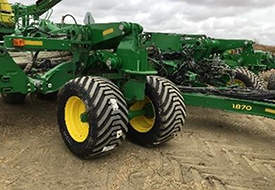
For small-grain producers who want to increase flotation and reduce compaction, a high-flotation kit is available for the 23.2-m (76-ft) 1870 Precision Hoe Drill.
Customer value
The high-flotation kit for the 23.2-m (76-ft) 1870 Precision Hoe Drill provides producers with excellent performance, a boost in uptime, and reduced cost of operation. The high-flotation package consists of two main components: larger front mainframe tires and an in-frame lift assist system. This complete package results in:
- 91.7 percent increase in flat plate area for front wheels
- 60 percent improvement in stuck factor for wheels
- Reduction in tire inflation pressures
- Reduction in ground pressures
- Ability to get in the field sooner if desired
How it works
The high-flotation kit works in two ways:
- The larger front mainframe tires add an increase in flotation to the front of the machine.
- The in-frame lift assist system utilizes the power beyond circuit and a hydraulic valve block to set system pressure, utilizing accumulators to raise and lower the system. The in-frame system has new components to be installed within the existing mainframe to increase flotation and allow the machine weight to be spread across additional tire surface area.
High-flotation kit components
Larger front mainframe tires:


The mainframe and wing wheel scrapers have been redesigned to better meet producer needs. These scrapers are included in the high-flotation kit. BA33708 can also be ordered separately if the grower does not want the flotation kit.
| Attachment | Description |
| BA33708 | Main frame and wing wheel scrapers NOTE: Order one kit per 23.2-m (76-ft) 1870 Drill. |


This kit does not include any 440/55R18 tires for the lift assist system. The producer will use the 440/55R18 tires from the mainframe front that will be replaced by 550/45-22.5 tires as part of the kit pre-delivery inspection (PDI) process.
Compatibility
This kit is compatible with all 23.2-m (76-ft) 1870 Precision Hoe Drills.
Ordering
This kit will be initially offered as a product enhancement program (PEP). See PEP #18AX461 for more details.
| Attachment | Description |
| MPA10950 | 23.2-m (76-ft) 1870 High-flotation PEP kit NOTE: Includes larger front tires and assembly and lift assist system. Does not include 440/55R18 tires. |
Mainframe and wing wheel scrapers
 Front mainframe tires
Front mainframe tires
 91.7 percent increase in flat plate area
91.7 percent increase in flat plate area
| Standard front tires | High-flotation front tires | |
| Tire | 440/55R18 | 550/45-22.5 |
| Load capacity | 4377.2 kg (9650 lb) | 3646.9 kg (8040 lb) |
| Inflation pressure | 5 bar (73 psi) | 1.5 bar (22 psi) |
| Outside diameter | 94.2 cm (37.1 in.) | 106.9 cm (42.1 in.) |
| Width | 43.4 cm (17.1 in.) | 55.1 cm (21.7 in.) |
| Static loaded radius | 42.2 cm (16.6 in.) | 47 cm (18.5 in.) |
| Flat plate area | 1006.5 cm2 (156 sq in.) | 1929 cm2 (299 sq in.) |
Lift assist system:
Features
Longer machine life with flexible frame
 Side-to-side flexibility demonstrated by 1830
Side-to-side flexibility demonstrated by 1830
Most producers view purchasing a seeding system as a long-term investment. The life requirement of these robust machines is four times longer than previous models. That is why the John Deere seeding group has built even more durability into the 1830 and 1835 Air Hoe Drills.
An advanced and rigorous testing program has proven the machine durability to the extent that John Deere now offers a three-year frame warranty with each 1830 and 1835 that rolls out of the factory.
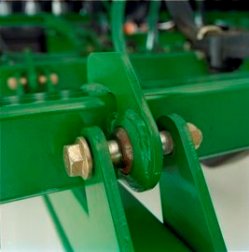 Robust ball joints
Robust ball joints
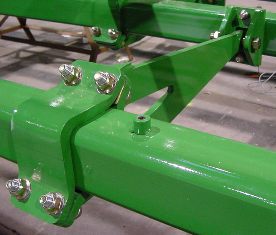 Cast rank tube connectors
Cast rank tube connectors
Robust ball joints connect strong fore-aft tubes to 100-mm x 100-mm (4-in. x 4-in.) rank tubes, which are joined to one another by pivoting rank connectors. Both the mainframe and wing sections share this durable construction that enables the frame to flex diagonally, relieving stress on solid frame members and avoiding frame failures.
Seed smart with confidence that the 1830 and 1835 will endure the field conditions.
Seed depth uniformity
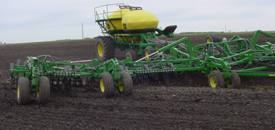 Diagonal frame flexibility keeps openers engaged
Diagonal frame flexibility keeps openers engaged
Producers are more attuned to the importance of seed depth than ever before. A uniform-looking field is not the only goal; yield is too. Proven yield penalties across the world range from 5 percent to 25 percent, depending on depth variance.
The 1830 and 1835 feature diagonal mainframes and wing flexing – helping openers maintain their depth over uneven terrain.
Positive depth control features and options
Setting depth is one of the most critical adjustments an operator will make to a seeding tool. John Deere understands every operator needs dependable, repeatable depth control that is easily adjustable. Not every producer agrees on how to make it. That is why John Deere provides a choice of two depth control options on the 1830 and 1835.
Mechanical depth shims are repeatable and reliable
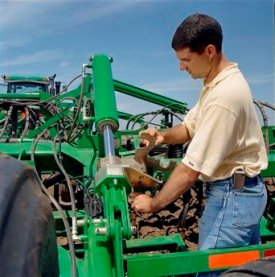 Adjusting mechanical depth shims
Adjusting mechanical depth shims
Often-heard are comments from producers who say they prefer the positive mechanical depth control offered by the 1820. This popular concept is base equipment on the 1830 and 1835 air hoe drills.
Two indexed depth shim packs on the mainframe are not only easy to set, but reduce the number of adjustment sites over previous designs by up to 60 percent.
Less time adjusting means more time seeding.
TouchSet™ depth control
Changing field conditions such as moisture levels and soil types can make setting depth a challenge. TouchSet depth control makes adjusting depth in response to changing field conditions easy and profitable. On 8R and 9R Series tractors, the operator uses selective control valve (SCV) #1 and the SCV TouchSet control panel to perform all the depth control functions from the seat. Considering yield penalties of 5 percent due to seeding 2.5 cm (1 in.) too deep or too shallow, the convenience of in-cab adjustment pays nicely.
NOTE: Repeatability is +/- 6 mm (0.25 in.) to preset depth. If your seeding operation requires accuracy greater than +/- 6 mm (0.25 in.), the use of shim packs is recommended.
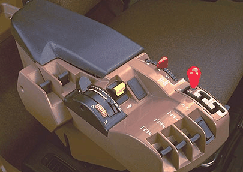 Control arm
Control arm
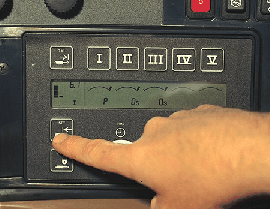 CommandCenter™
CommandCenter™
How does it work? The operator uses the TouchSet (SCV setup panel) to set or change the operator depth.
-
With the implement nine-pin connector connected to the tractor, start the tractor; a P will appear in the window of the control panel under SCV #1.
-
The remote sensor located on the rockshaft monitors position of the implement.
-
After operating depth is measured at the ground engaging tool and the desired depth obtained, press the lower set button on the control panel. That depth is now set.
-
On-the-go depth changes can be made by touching the set button to select a new depth.
-
Implement raise height selection uses the upper set button on the control panel to preset the distance the implement is raised above the operating depth.
Preset the raise height to:
-
Take out wheel tracks on headlands
-
Limit raise height for waterway crossings
-
Manual depth override capacity
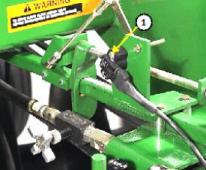 Remote position sensor
Remote position sensor
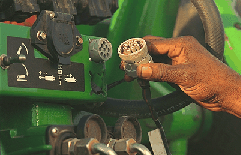 Electrical connector
Electrical connector
A remote position sensor (1) is located at the rear of the drill; electronically monitors the positions of the implement.
An electrical connector is used for easy hookup of TouchSet depth control sensor on the implement to the tractor system (8R Tractor illustrated).
NOTES:
-
For use with all 8R and 9R (or older models) Series John Deere tractors.
-
TouchSet depth control requires additional tractor parts for hookup; see appropriate tractor section in this Sales Manual.
1830
Code |
Bundle |
Description |
2500 |
|
Positive mechanical depth control |
2505 |
|
TouchSet depth control plus positive mechanical depth control |
1835
Code |
Bundle |
Description |
2510 |
|
Positive mechanical depth control with active hydraulic down-pressure system for separate fertilizer placement (SFP) |
2515 |
|
TouchSet depth control and positive mechanical depth control with active hydraulic down-pressure system for SFP |
Stabilize nitrogen retention with separate fertilizer placement (SFP)
Fertilizer inputs can represent 30 percent to 35 percent of the cost in small-grain and oil seed production. It is no wonder producers are concerned about nitrogen losses from gas escape, volatilization, and leaching.
Nitrogen loss pathways
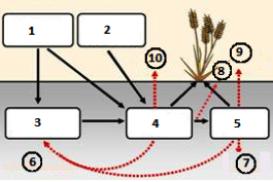 Manage nitrogen to minimize losses
Manage nitrogen to minimize losses

- Manure and crop residues
- 46-0-0
82-0-0
28-0-0 (75 percent) - Soil organic N
- Ammonium NH4+
- Nitrate NO3+
- Immobilization
- Leaching and runoff
- NO
N2O - N2+
N20 Denitrification - NH3 Volatilization
Nitrogen (N) loss occurs via four key pathways.
- Volatilization of anhydrous ammonia (NH3) into the atmosphere.
- Immobilization, or the uptake of nitrogen by microbes breaking down residue.
- Leaching or runoff of N2 or NO2 (nitrite).
- Volatilization of N2 or NO2 (nitrite).
Denitrification is the conversion of nitrate (NO3) to nitrite (NO2), and eventually to N2 or N2O (nitrous oxide). These nitrogen forms are not held by the soil complex like NO3 and NH4 and are subject to escape via water.
SFP opener prevents nitrogen loss
 SFP opener
SFP opener

The SFP opener features:
- Single-disk blade slices through the soil at a five-degree angle
- Opener is adjusted via active hydraulic-down pressure
- Depth gauging is accomplished at the opener
- Closing wheel ensures fertilizer stays where it is applied
Ultra-low soil, moisture, and residue disturbance, plus the cast closing wheel, are able to lock in dry, liquid or gaseous fertilizer.
IMPORTANT: Furrow closing wheels are required when applying anhydrous fertilizer.
Plus, application at seeding means no more worrying about pre-season nitrogen loss due to de-nitrification and leaching. Reduce dependence on risky top-dress applications where volatilization and immobilization can significantly reduce crop uptake. Fertilizer can now be applied in the seeding operation with confidence, knowing it is firmly in place where it belongs in the soil.
Apply fertilizer at a safe distance with Separate Fertilizer Placement (SFP)
Researchers observed stand reductions up to 5 percent in wheat and 26 percent in canola (PAMI 738) when nitrogen fertilizer was placed near the seed. Those are the risks and possible consequences for nitrogen application too close to the seed.
 1835 seeding wheat and applying ammonia separately
1835 seeding wheat and applying ammonia separately
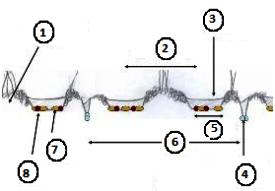 1835 with SFP, 10.2-cm (4-in.) points and 10.2-cm (4-in.) packers
1835 with SFP, 10.2-cm (4-in.) points and 10.2-cm (4-in.) packers
- Undisturbed soil
- 25.4 cm (10 in.)
- Disturbed soil packed over seed row
- SFP nitrogen
- 10.2 cm (4 in.)
- 50.8 cm (20 in.)
- Seed
- Seep-placed phosphorus
John Deere seeding group thinks sound nitrogen management should be rewarded. That is why the 1835 SFP Air Hoe Drill was designed with the exclusive SFP opener to place nitrogen, potassium and sulfur-based fertilizers separate from the seed. This positive separation of fertilizer and seed eliminates seedling damage caused by some fertilizer forms and application methods.
Understanding distance between seed and fertilizer placement
When seeding with the 1835 SFP, the seed opener will have an effect on the distance between the seed and fertilizer. For example, as the diagram above shows, seeding with a 10.2-cm (4-in.) spread places the seed between 20.3 cm (8 in.) and 30.5 cm (12 in.) from the fertilizer in the same furrow.
NOTE: Narrow spread openers are recommended to keep a consistent distance between seed and fertilizer.
IMPORTANT: The 1835 SFP is also capable of applying safe rates of starter fertilizer with the seed.
Reduce nitrogen costs with Separate Fertilizer Placement (SFP)
Nitrogen application timing
 Manage nitrogen to minimize losses
Manage nitrogen to minimize losses

- Manure and crop residues
- 46-0-0
82-0-0
28-0-0 (75 percent) - Soil organic N
- Ammonium NH4+
- Nitrate NO3+
- Immobilization
- Leaching and run off
- NO
N2O - N2+
N2O De-nitirfication - NH3 Volatilization
The United States Department of Agriculture (USDA) data suggests spring wheat producers who apply nitrogen at seeding typically cut their application rates by 15 percent when compared to pre-seeding applications. This is driven by the reduced risk of environmental loss.
Ammonium (NH4) can eventually transform to the nitrate (NO3) form of nitrogen. The longer the nitrate form of nitrogen is exposed to wet soil conditions, the more of it is converted to nitrite (NO2) and other lesser oxidized forms of nitrogen through denitrification. These nitrogen forms are very unstable and are subject to leaching through the soil profile, rendering them unavailable to the crop. To compensate for this potential loss of nitrogen, it is recommended to apply 15 percent more nitrogen in the fall.
Applying anhydrous ammonia at seeding, close to the time of crop uptake, can, in fact, reduce the actual amount of applied nitrogen to achieve a given yield. Given a rate of 18-kg (100-lb) of nitrogen per hectare, a price of 10 cent per kg ($0.30 per pound), and when used in an application over 1200 ha, the nitrogen rate is cut by 15 percent, which means a cost saving of 10.800 Euro ($13,500).
Nitrogen sources
Most years, producers can save 10 percent in their nitrogen costs by using low-cost, concentrated anhydrous ammonia (NH3) instead of granular urea.
Example:
- 3000 acre farm
- Nitogren at 85 lb / acre
- $0.03 differential in cost
- Results in savings of $7,650
Separate fertilizer placement (SFP)
Fertilizer inputs can represent 30 percent to 35 percent of the cost in small grain and oil seed production. It is no wonder farmers are concerned about nitrogen losses from gas escape, volatilization and leaching.
One opener combines four key processes to minimize nutrient losses through precise nutrient placement at seeding. John Deere’s SFP disc opener features:
- Active hydraulic downforce
- Depth gauging at the opener
- Ultra-low soil and residue disturbance
- Positive closing system
All of these lock in dry, liquid, or gas forms of nitrogen.
There is no more worrying about pre-season nitrogen loss due to denutrification and leaching. Operators can forget about volatilization of top-dress applications, and maybe most notably, endure a day of seeding without the burning nasal passages that accompany poor anhydrous ammonia retention.
SFP opener with 5-degree angle
 SFP opener
SFP opener
Key features of the opener include:
- Depth gauging at the opener with 11.4-cm (4.5-in.) or 7.6-cm (3-in.) semi-pneumatic gauge wheels
- Depth adjustments are in 6 mm (1/4 in.) increments from 1.3-cm (1/2-in.) to 9-cm (3-1/2-in.) deep
- 5-degree operating angle creates a narrow trench and minimizes soil disturbance
- Close-coupled closing wheel assembly for quick trench closure and maximum fertilizer retention
- NOTE: Closing wheels are base equipment on anhydrous openers and optional on liquid and dry openers. Closing wheels are recommended.
- Extended-wear (chrome alloy) fertilizer boots
- Sealed, non-greaseable bearings
Fertilizer tubes
There are four choices of interchangeable fertilizer tubes:
A) Dry fertilizer tube to be used with 32-mm (1-1/4-in.) secondary fertilizer hose from the 1910 Commodity Cart.
B) Liquid fertilizer tube (for 13-mm [1/2-in.] ID hose). Using this tube for anhydrous may cause loss of retention.*
C) Dual fertilizer delivery tube. Allows for placement of dry or anhydrous. If applying both simultaneously, the operator may need to provide a relief system to relieve air from dry tube for adequate anhydrous retention. Without air relief, the operator will need to adjust air plenum to restrict all airflow to SFP dry tubes when anhydrous is being applied.*
D) Anhydrous tube (for 10-mm [3/8-in.] ID hose).*
* NOTE: Liquid or NH3 Fertilizer metering/delivery system is not provided by the John Deere seeding group.
Code |
Bundle |
Description |
| 1205 | Dry fertilizer delivery tube | |
| 1215 | Liquid fertilizer delivery tube | |
| 1220 | Dual delivery tubes | |
| 1225 | Anhydrous fertilizer delivery tube |
Opener gauge wheel
11.4-cm x 40.6-cm (4.5-in. x 16-in.) semi-pneumatic wheel gauges depth
- Standard smooth plastic hub for minimal soil disturbance in mellow soils
- Depth can be controlled from 0.6 x 9 cm (1/4 to 3-1/2 in.) in 6-mm (1/4-in.) increments (13 total adjustments)
- Runs on sealed, double row tapered ball bearings
7.6-cm x 40.6-cm (3-in. x 16-in.) gauge wheel (optional)
- Less stubble or residue disturbance
- Depth can be controlled from 0.6 to 9 cm (1/4 to 3-1/2 in.) in 6-mm (1/4-in.) increments (13 total adjustments)
Code |
Bundle |
Description |
| 1605 | Smooth-side gauge wheel | |
| 1610 | Narrow gauge wheel (7.6 cm [3 in.] in width) |
Opener furrow closing wheel
2.5-cm x 30.5-cm (1-in. x 12-in.) cast closing wheel follows the press wheel to close furrow, placing soil over seed or fertilizer after the press wheel secures seed in furrow.
- A double-row ball bearing to reduce wear is located in the arm of the closing wheel
- Mounted parallel to the furrow opener, the closing wheel can be adjusted laterally to allow running on top of furrow for sandy or mellow soils or to side of furrow for heavier soils
- Down pressure is adjustable from 12 kg to 19.5 kg (26 lb to 43 lb) (no tools and three adjustments).
NOTE: Closing wheel is optional on fertilizer openers.
Code |
Bundle |
Description |
| 1701 | Less cast closing wheel | |
| 1707 | Cast serrated fertilizer closing wheel |
Serrated closing wheel
 Serrated closing wheel
Serrated closing wheel
The serrated closing wheel offers an improved closing system when seeding in harder, dryer conditions. The notches on the wheel break up the dryer conditions while offering an improved sealing that will directly promote better germination which supports and increases flowering and even / fuller canopy overall. By sealing off the trench, there is less outgassing of anhydrous, offering a safer environment for the producer. By less outgassing, there is a higher opportunity for increased yields stemming from better germination
Reduce transport height
Transporting large machines on public roads can be a little stressful. Passing motorists, mailboxes, overhead lines, and trees can all contribute to potential hazards.
With so much to focus on, the 1830 Air Hoe Drill operator should not have to worry about openers engaging the pavement when lowering a machine to clear an overhead obstacle.
With the optional transport height reduction feature, the operator does not need to worry. This handy feature can also serve to set the height for storage inside.
How it works
 Transport height reduction assembly
Transport height reduction assembly
Simply setting the pin in the appropriate hole will stop the machine from lowering when the openers are a safe distance above the pavement.
The operator can focus on the overhead obstacle and other hazards such as passing motorists near the machine. This can prevent a potentially damaging encounter with the road surface or even an accident.
TruPosition™ standards
TruPosition 250-kg (550-lb) trip force
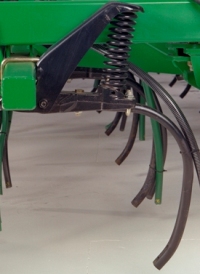 250-kg (550-lb) trip-force TruPosition standard
250-kg (550-lb) trip-force TruPosition standard

Unmoved
That is how John Deere's TruPosition standard may be described. When the seed depth consistency and row spacing integrity are top concerns, this low-maintenance design will not compromise.
This can translate to a more than 5 percent yield increase by maintaining seed depth in tough ground conditions. The no-bolt design means avoiding maintenance costs and damaging downtime down the road.
It has a 51-degree shank.
Harrow
Seed depth consistency is a function of initial seed placement below the soil surface and displacement of soil over the seed row. When soil throw from the openers is great enough to cover up neighboring seed rows, a harrow is recommended to level the seedbed and equalize displaced soil over all seed rows prior to packing.
 1830 with sweeps, harrow, and 14-cm (5.5-in.) packers
1830 with sweeps, harrow, and 14-cm (5.5-in.) packers

Equipping an 1830 with the optional two-bar harrow helps level the seedbed before packing, ensuring an even distribution of soil over all seed rows. Adjustments include both vertical and tine-pitch, allowing the operator to set the harrow for the level of aggressiveness needed to level the seedbed.
NOTE: Not recommended for seeding into surface residue levels exceeding 35 percent.
NOTE: Harrow is not compatible with 1835.
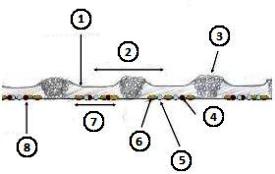 1830 on 25.4-cm (10-in.) spacing, 30.5-cm (12-in.) sweep, harrow
1830 on 25.4-cm (10-in.) spacing, 30.5-cm (12-in.) sweep, harrow

- Disturbed soil packed over seed row with 14-cm (5.5-in.) semi-pneumatic packer.
- 25.4 cm (10 in.)
- Tilled soil
- Seed-placed phosphorus
- Seed-placed nitrogen
- Seed
- 17.8 cm (7 in.)
- Seed floor created by sweep
The seeding profile behind an 1830 equipped with a harrow and sweeps will look similar to the image on the left. A flat seed floor with seed distributed over 50 percent of the row spacing for 25.4-cm (10-in.) configurations using the Perma-Loc™ boot and sweep.
1830:
Code |
Bundle |
Description |
1000 |
* |
250-kg (550-lb) TruPosition opener on four ranks, less harrow |
1015 |
* |
250-kg (550-lb) TruPosition opener on front three ranks, double-bar harrow |
1835:
Code |
Bundle |
Description |
1005 |
* |
250-kg (550-lb) TruPosition opener on rear three ranks and separate fertilizer placement (SFP) disk openers on front rank |
1830 and 1835 Air Hoe Drills hydraulic lift circuit
The 1830 and 1835 feature a simplified hydraulic system due to a common rockshaft design in the lift circuit. Not only does this tie all sections together ensuring consistent depth from mainframe to wing, it also eliminates 50 percent to 67 percent of the hydraulic cylinders, reducing the chance of hydraulic failure.
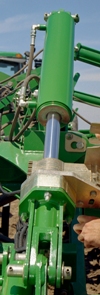 Frame lift cylinder
Frame lift cylinder
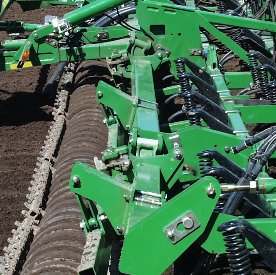 Common rockshaft design
Common rockshaft design
-
No rephasing of hydraulic cylinders
-
Fewer hydraulic components and hoses to maintain
-
Seed with confidence that all air hoe drill sections are seeding at the same depth
Choice of ground-engaging openers
Knife bodies and points
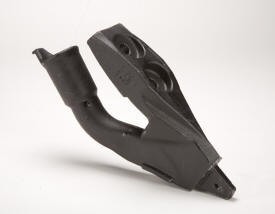 Knife body
Knife body
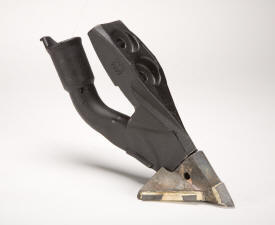 Knife body with 10.2 cm (4 in.) point
Knife body with 10.2 cm (4 in.) point
Many producers enjoy the moisture-saving benefits of low-disturbance seeding. To make it easier for them to reap the rewards of low-disturbance seeding, factory-installed knife bodies are available for 1830 and 1835 Drills.
The knife bodies are available in 2.5 cm (1 in.) or 10.2 cm (4 in.) spread points.
Use the 2.5-cm (1-in.) point for low disturbance or, if a wider spread pattern is desired to increase seedbed utilization, use the 10.2-cm (4-in.) point. The points can be quickly changed with a single roll-pin fastening system and feature carbide tips to ensure long life.
The knife bodies also feature a positive hose retention system with provisions for a hose clamp to hold the hose in place.
These knife bodies may not perform as designed in wet, sticky soil conditions.
NOTE: Points and roll pins are not included. Points and roll pins are available through Service Parts.
Perma-Loc™ spoons and sweeps
Perma-Loc spoons and sweeps from John Deere offer reduced maintenance because the Perma-Loc design enables a change-out up to five times faster than traditional bolt-on components.
They also offer cost savings because with Perma-Loc spoons and sweeps, there is no more purchasing hardware each time spoons are changed out. This can save $309 USD list price when changing out the spoons on a 18.3-m (60-ft) tool with 19-cm (7.5-in.) spacing.
Save time and money and seed smart with John Deere Perma-Loc spoons or sweeps.
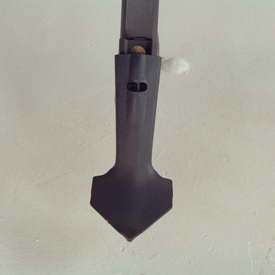 10.2-cm (4-in.) Perma-Loc spoon
10.2-cm (4-in.) Perma-Loc spoon
 10.2-cm (4-in.) Perma-Loc spoon
10.2-cm (4-in.) Perma-Loc spoon
Shown is the 10.2-cm (4-in.) Perma-Loc spoon; 7.6-cm (3-in.) spoons are also available.
Spoons are not included in base price and must be ordered separately.
Below is the seedbed profile that can be expected if using a 10.2-cm (4-in.) spoon in conventional tillage with the 1835 Separate Fertilizer Placement (SFP).
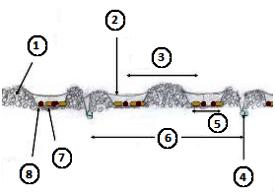 10.2-cm (4-in.) Perma-Loc spoon
10.2-cm (4-in.) Perma-Loc spoon

- Tilled soil
- Disturbed soil packed over seed row
- 25.4 cm (10 in.)
- Separate fertilizer placement nitrogen
- 10.2 cm (4 in.)
- 50.8 cm (20 in.)
- Seed
- Seed-placed phosphorus
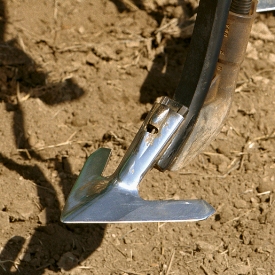 30.5-cm (12-in.) Perma-Loc sweep and boot
30.5-cm (12-in.) Perma-Loc sweep and boot
 Seedbed profile - 1830 and 30.5-cm (12-in.) Perma-Loc sweeps
Seedbed profile - 1830 and 30.5-cm (12-in.) Perma-Loc sweeps
- Disturbed soil packed over seed row with 14-cm (5.5-in.) semi-pneumatic packer
- 25.4 cm (10 in.)
- Tilled soil
- Seed-placed phosphorus
- Seed-placed nitrogen
- Seed
- 17.8 cm (7 in.)
- Seed floor created by sweep
Codes for ground-engaging openers
Code |
Bundle |
Description |
5000 |
|
Perma-Loc clip and seed boot for TruPosition™ standard
|
5001 |
|
Perma-Loc clip and seed boot for TruPosition openers with sweeps
|
5005 |
* |
Knife body for TruPosition standard |
5006 |
|
Knife body with 2.5-cm (1-in.) tip for TruPosition openers |
5007 |
|
Knife body with 10.2-cm (4-in.) tips for TruPosition openers |
5010 |
* |
Less ground-engaging tools and seed boot for TruPosition and spring-cushion openers |
Perma-Loc removal tool
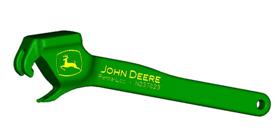 Perma-Loc removal tool
Perma-Loc removal tool
This handy Perma-Loc removal tool should be ordered for each drill ordered with Perma-Loc components.
Separate fertilizer placement (SFP) offers growing advantages
 SPF Openers
SPF Openers
Separate fertilizer placement offers nutrient placement at a 5 or 7-degree angle
The 5-degree fertilizer opener:
- Is required for liquid and anhydrous (NH3) fertilizers
- Will also apply dry fertilizer
- Opens a smaller trench than the 7-degree opener
- Is better able to capture anhydrous and liquid fertilizer and seal fertilizers in the soil
Fertilizer tubes
There are four choices of interchangeable fertilizer tubes:
- Dry fertilizer tube to be used with 32-mm (1-1/4-in.) secondary fertilizer hose from the 1910 Cart
- Liquid fertilizer tube (for 13-mm [1/2-in.] i.d. hose)
- IMPORTANT: Using this tube for anhydrous may cause loss of retention
- Dual fertilizer delivery tube – allows for placement of dry or anhydrous. If applying both simultaneously, the operator may need to provide a relief system to relieve air from dry tube for adequate anhydrous retention. Without air relief, the operator will need to adjust air plenum to restrict all airflow to SFP dry tubes when anhydrous is being applied
- Anhydrous tube (for 10-mm [3/8-in.] i.d. hose)
- Liquid or NH3 fertilizer metering/delivery system is not provided by the John Deere Seeding Group
Key features of the SFP opener are:
- 457.2-mm (18-in.) opener blades operate at 5 degrees, resulting in a narrow trench with less soil disturbance
- Fertilizer tubes are interchangeable among dry, liquid, or anhydrous (NH3)
- Closing wheel assembly is closer to the fertilizer delivery tube; provides increased fertilizer retention
- Serrated closing wheels are base equipment on anhydrous openers and optional on liquid and dry openers
- NOTE: Closing wheels are recommended when dry soil conditions are common.
- Extended-wear (chrome alloy) fertilizer boots are standard equipment
- Choice of five different gauge wheels
- Depth adjustments in 6-mm (1/4-in.) increments from 13 mm to 89 mm (1/2 in. to 3.5 in.) deep
Opener furrow-closing wheel
The 25-mm x 305-mm (1-in. x 12-in.) cast closing wheel follows the press wheel to close the furrow, placing soil over seed or fertilizer after the press wheel secures the seed in the furrow.
- A double-row ball bearing to reduce wear is located in the arm of the closing wheel
- Mounted parallel to the furrow opener, the closing wheel can be adjusted laterally to allow running on top of the furrow for sandy or mellow soils or to side of the furrow for heavier soils
- Down pressure is adjustable from 11.8 kg to 19.5 kg (26 lb to 43 lb) (no tools and three adjustments)
- A grease fitting in the pivot arm provides free movement for the arm
Features
Longer machine life with flexible frame
 Side-to-side flexibility demonstrated by 1830
Side-to-side flexibility demonstrated by 1830
Most producers view purchasing a seeding system as a long-term investment. The life requirement of these robust machines is four times longer than previous models. That is why the John Deere seeding group has built even more durability into the 1830 and 1835 Air Hoe Drills.
An advanced and rigorous testing program has proven the machine durability to the extent that John Deere now offers a three-year frame warranty with each 1830 and 1835 that rolls out of the factory.
 Robust ball joints
Robust ball joints
 Cast rank tube connectors
Cast rank tube connectors
Robust ball joints connect strong fore-aft tubes to 100-mm x 100-mm (4-in. x 4-in.) rank tubes, which are joined to one another by pivoting rank connectors. Both the mainframe and wing sections share this durable construction that enables the frame to flex diagonally, relieving stress on solid frame members and avoiding frame failures.
Seed smart with confidence that the 1830 and 1835 will endure the field conditions.
Seed depth uniformity
 Diagonal frame flexibility keeps openers engaged
Diagonal frame flexibility keeps openers engaged
Producers are more attuned to the importance of seed depth than ever before. A uniform-looking field is not the only goal; yield is too. Proven yield penalties across the world range from 5 percent to 25 percent, depending on depth variance.
The 1830 and 1835 feature diagonal mainframes and wing flexing – helping openers maintain their depth over uneven terrain.
Positive depth control features and options
Setting depth is one of the most critical adjustments an operator will make to a seeding tool. John Deere understands every operator needs dependable, repeatable depth control that is easily adjustable. Not every producer agrees on how to make it. That is why John Deere provides a choice of two depth control options on the 1830 and 1835.
Mechanical depth shims are repeatable and reliable
 Adjusting mechanical depth shims
Adjusting mechanical depth shims
Often-heard are comments from producers who say they prefer the positive mechanical depth control offered by the 1820. This popular concept is base equipment on the 1830 and 1835 air hoe drills.
Two indexed depth shim packs on the mainframe are not only easy to set, but reduce the number of adjustment sites over previous designs by up to 60 percent.
Less time adjusting means more time seeding.
TouchSet™ depth control
Changing field conditions such as moisture levels and soil types can make setting depth a challenge. TouchSet depth control makes adjusting depth in response to changing field conditions easy and profitable. On 8R and 9R Series tractors, the operator uses selective control valve (SCV) #1 and the SCV TouchSet control panel to perform all the depth control functions from the seat. Considering yield penalties of 5 percent due to seeding 2.5 cm (1 in.) too deep or too shallow, the convenience of in-cab adjustment pays nicely.
NOTE: Repeatability is +/- 6 mm (0.25 in.) to preset depth. If your seeding operation requires accuracy greater than +/- 6 mm (0.25 in.), the use of shim packs is recommended.
 Control arm
Control arm
 CommandCenter™
CommandCenter™
How does it work? The operator uses the TouchSet (SCV setup panel) to set or change the operator depth.
-
With the implement nine-pin connector connected to the tractor, start the tractor; a P will appear in the window of the control panel under SCV #1.
-
The remote sensor located on the rockshaft monitors position of the implement.
-
After operating depth is measured at the ground engaging tool and the desired depth obtained, press the lower set button on the control panel. That depth is now set.
-
On-the-go depth changes can be made by touching the set button to select a new depth.
-
Implement raise height selection uses the upper set button on the control panel to preset the distance the implement is raised above the operating depth.
Preset the raise height to:
-
Take out wheel tracks on headlands
-
Limit raise height for waterway crossings
-
Manual depth override capacity
 Remote position sensor
Remote position sensor
 Electrical connector
Electrical connector
A remote position sensor (1) is located at the rear of the drill; electronically monitors the positions of the implement.
An electrical connector is used for easy hookup of TouchSet depth control sensor on the implement to the tractor system (8R Tractor illustrated).
NOTES:
-
For use with all 8R and 9R (or older models) Series John Deere tractors.
-
TouchSet depth control requires additional tractor parts for hookup; see appropriate tractor section in this Sales Manual.
1830
Code |
Bundle |
Description |
2500 |
|
Positive mechanical depth control |
2505 |
|
TouchSet depth control plus positive mechanical depth control |
1835
Code |
Bundle |
Description |
2510 |
|
Positive mechanical depth control with active hydraulic down-pressure system for separate fertilizer placement (SFP) |
2515 |
|
TouchSet depth control and positive mechanical depth control with active hydraulic down-pressure system for SFP |
Five tire options for 1830 Air Hoe Drills
The correct tires are critical to the overall performance and productivity of an air hoe drill. The John Deere Seeding Group recognizes the wide variance in conditions and tire needs around the world. Five tire options are provided for the 1830 Air Hoe Drill.
To select the appropriate tire, consider the discussions and matrixes below.
Wheels in base equipment on 1830 mainframe are:
- Dual front caster wheels
- Dual rear transport wheels
Equip the wing sections with duals in the following situations:
- Maximum flotation is required for wetter soils or conditions
- No requirement to have openers seeding outboard the outer wing caster tire
- Rough field conditions that could lead to potentially inconsistent seed depth
12.5L-15 tires - base equipment for 1830
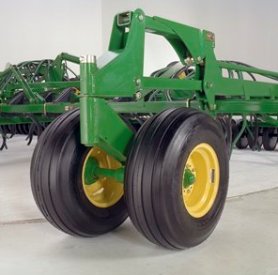 12.5L-15 tire
12.5L-15 tire
The 12.5L-15 tire (code 2210 or 2215) brings load-carrying capacity and puncture resistance.
For additional capabilities in the following situations, consider optioning up to high-flotation, wide-profile knobby tire option (code 2220):
- Transporting on soft, rural roads
- Operating in generally wetter, softer field conditions
- Additional puncture resistance is required
33x15.5-16.5 and 31x13.5-15 high-flotation tires
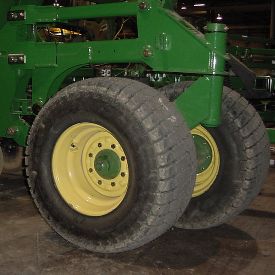 33x15.5-16.5 tire
33x15.5-16.5 tire
 31x13.5-15 tire
31x13.5-15 tire
The high-flotation tires (code 2220) provide the best performance in all categories with the exception of tire overlap (pass-to-pass) and replacement tire considerations. The size of the machine will depict whether the mainframe will receive 33x15.5-16.5 or 31x13.5-15 size tires (see matrix below).
Tire selection by base code and option code
What tires are included with each base code and option code? This can be a complicated question and present unwarranted confusion. Each machine configuration is equipped with the tire that is meets the minimum load carrying capacities required of the machine size. Below is a chart that describes the tire that accompanies each code.
Code |
|
2210 |
2215 |
2220 |
Wing configuration |
|
Single |
Dual |
Dual |
Model/size |
||||
1830-34 |
Mainframe duals |
12.5L15 FI LR D |
12.5L15 FI LR D |
31x13.5-15 10 PR |
|
Wing |
12.5L15 FI LR D |
12.5L15 FI LR D |
31x13.5-15 10 PR |
1830-41 |
Mainframe duals |
12.5L15 FI LR D |
12.5L15 FI LR D |
31x13.5-15 10 PR |
|
Wing |
12.5L15 FI LR D |
12.5L15 FI LR D |
31x13.5-15 10 PR |
1830-50 |
Mainframe duals |
12.5L15 FI LR D |
12.5L15 FI LR D |
33x15.5-16.5 10 PR |
|
Wing |
12.5L15 FI LR D |
12.5L15 FI LR D |
31x13.5-15 10 PR |
1830-61 (18.60 ) |
Mainframe duals |
12.5L15 FI LR F |
12.5L15 FI LR F |
33x15.5-16.5 10 PR |
|
Wing |
12.5L15 FI LR D |
12.5L15 FI LR D |
31x13.5-15 10 PR |
1835-41,50 (12.50 & 15.20 m |
Mainframe duals |
12.5L15 FI LR D |
12.5L15 FI LR D |
33x15.5-16.5 10 PR |
|
Wing |
12.5L15 FI LR D |
12.5L15 FI LR D |
31x13.5-15 10PR |
1835-61 |
Mainframe duals |
12.5L15 FI LR F |
12.5L15 FI LR F |
33x15.5-16.5 10 PR |
|
Wing |
12.5L15 FI LR D |
12.5L15 FI LR D |
31x13.5-15 10 PR |
To determine which code is most appropriate for a given situation, see the chart below, which outlines some considerations for tire package selection.
Tire code suitability by application
Code |
|
2210 |
2215 |
2220 |
Wing configuration |
|
Single |
Dual |
Dual |
Selection criteria |
Application |
|||
Load rating |
Extensive road transport or heavy options |
Best |
Best |
Better |
Flotation - Road transport |
Transport on soft rural roads |
Good |
Good |
Best |
Flotation - Field edges |
Operation around field wet spots |
Good |
Better |
Best |
Puncture and stubble resistance |
Road and field hazards or tough stubble |
Better |
Better |
Best |
Wing operation stability |
Operation in rough fields |
Good |
Best |
Best |
Overlap with previous pass |
Operation without guidance systems |
Best |
Better |
Good |
Availability of replacement tires |
Operation far from retail centers |
Better |
Better |
Good |
Cost of replacement tires |
|
Better |
Better |
Good |
Reduce transport height
Transporting large machines on public roads can be a little stressful. Passing motorists, mailboxes, overhead lines, and trees can all contribute to potential hazards.
With so much to focus on, the 1830 Air Hoe Drill operator should not have to worry about openers engaging the pavement when lowering a machine to clear an overhead obstacle.
With the optional transport height reduction feature, the operator does not need to worry. This handy feature can also serve to set the height for storage inside.
How it works
 Transport height reduction assembly
Transport height reduction assembly
Simply setting the pin in the appropriate hole will stop the machine from lowering when the openers are a safe distance above the pavement.
The operator can focus on the overhead obstacle and other hazards such as passing motorists near the machine. This can prevent a potentially damaging encounter with the road surface or even an accident.
1830 and 1835 Air Hoe Drills hydraulic lift circuit
The 1830 and 1835 feature a simplified hydraulic system due to a common rockshaft design in the lift circuit. Not only does this tie all sections together ensuring consistent depth from mainframe to wing, it also eliminates 50 percent to 67 percent of the hydraulic cylinders, reducing the chance of hydraulic failure.
 Frame lift cylinder
Frame lift cylinder
 Common rockshaft design
Common rockshaft design
-
No rephasing of hydraulic cylinders
-
Fewer hydraulic components and hoses to maintain
-
Seed with confidence that all air hoe drill sections are seeding at the same depth
Choice of ground-engaging openers
Knife bodies and points
 Knife body
Knife body
 Knife body with 10.2 cm (4 in.) point
Knife body with 10.2 cm (4 in.) point
Many producers enjoy the moisture-saving benefits of low-disturbance seeding. To make it easier for them to reap the rewards of low-disturbance seeding, factory-installed knife bodies are available for 1830 and 1835 Drills.
The knife bodies are available in 2.5 cm (1 in.) or 10.2 cm (4 in.) spread points.
Use the 2.5-cm (1-in.) point for low disturbance or, if a wider spread pattern is desired to increase seedbed utilization, use the 10.2-cm (4-in.) point. The points can be quickly changed with a single roll-pin fastening system and feature carbide tips to ensure long life.
The knife bodies also feature a positive hose retention system with provisions for a hose clamp to hold the hose in place.
These knife bodies may not perform as designed in wet, sticky soil conditions.
NOTE: Points and roll pins are not included. Points and roll pins are available through Service Parts.
Perma-Loc™ spoons and sweeps
Perma-Loc spoons and sweeps from John Deere offer reduced maintenance because the Perma-Loc design enables a change-out up to five times faster than traditional bolt-on components.
They also offer cost savings because with Perma-Loc spoons and sweeps, there is no more purchasing hardware each time spoons are changed out. This can save $309 USD list price when changing out the spoons on a 18.3-m (60-ft) tool with 19-cm (7.5-in.) spacing.
Save time and money and seed smart with John Deere Perma-Loc spoons or sweeps.
 10.2-cm (4-in.) Perma-Loc spoon
10.2-cm (4-in.) Perma-Loc spoon
 10.2-cm (4-in.) Perma-Loc spoon
10.2-cm (4-in.) Perma-Loc spoon
Shown is the 10.2-cm (4-in.) Perma-Loc spoon; 7.6-cm (3-in.) spoons are also available.
Spoons are not included in base price and must be ordered separately.
Below is the seedbed profile that can be expected if using a 10.2-cm (4-in.) spoon in conventional tillage with the 1835 Separate Fertilizer Placement (SFP).
 10.2-cm (4-in.) Perma-Loc spoon
10.2-cm (4-in.) Perma-Loc spoon

- Tilled soil
- Disturbed soil packed over seed row
- 25.4 cm (10 in.)
- Separate fertilizer placement nitrogen
- 10.2 cm (4 in.)
- 50.8 cm (20 in.)
- Seed
- Seed-placed phosphorus
 30.5-cm (12-in.) Perma-Loc sweep and boot
30.5-cm (12-in.) Perma-Loc sweep and boot
 Seedbed profile - 1830 and 30.5-cm (12-in.) Perma-Loc sweeps
Seedbed profile - 1830 and 30.5-cm (12-in.) Perma-Loc sweeps
- Disturbed soil packed over seed row with 14-cm (5.5-in.) semi-pneumatic packer
- 25.4 cm (10 in.)
- Tilled soil
- Seed-placed phosphorus
- Seed-placed nitrogen
- Seed
- 17.8 cm (7 in.)
- Seed floor created by sweep
Codes for ground-engaging openers
Code |
Bundle |
Description |
5000 |
|
Perma-Loc clip and seed boot for TruPosition™ standard
|
5001 |
|
Perma-Loc clip and seed boot for TruPosition openers with sweeps
|
5005 |
* |
Knife body for TruPosition standard |
5006 |
|
Knife body with 2.5-cm (1-in.) tip for TruPosition openers |
5007 |
|
Knife body with 10.2-cm (4-in.) tips for TruPosition openers |
5010 |
* |
Less ground-engaging tools and seed boot for TruPosition and spring-cushion openers |
Perma-Loc removal tool
 Perma-Loc removal tool
Perma-Loc removal tool
This handy Perma-Loc removal tool should be ordered for each drill ordered with Perma-Loc components.
Hydraulic hose routing
Pinched hydraulic hoses lead to costly downtime. John Deere is aware producers expect machine reliability and a visually pleasing appearance when investing their hard-earned money in a new seeding tool. That is why the John Deere seeding group has placed extra emphasis on securely routing hydraulic hoses on the 1830 and 1835.
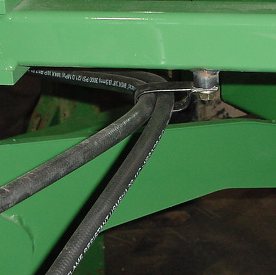 P-clamp
P-clamp
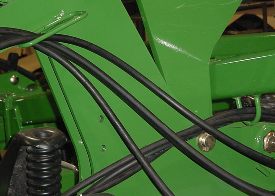 D-ring
D-ring
All 1830 and 1835 frames are manufactured with weldments to accommodate hose securement sites like the P-clamp and D-ring shown above.
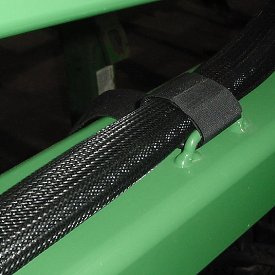 Velcro strap and protective sleeve
Velcro strap and protective sleeve
Innovative solutions like this Velcro® strap and protective sleeve ensure the reliability of the 1830 and 1835 measure up to John Deere standards. A machine-down repair that takes two hours to fix can mean over 20 ha (49 acres) of lost seeding time.
At a custom rate of $12 per hour, that is at least $600 of lost revenue, or lost yield, if seeding is delayed past mid May (wheat) for many locations.
Velcro is a trademark of Velcro Industries B.V.
Focused on proper air hose routing
Primary hose routing
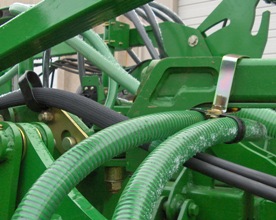 Clamps secure primary air hose
Clamps secure primary air hose
Considerable attention has been given to routing primary seed and fertilizer hose. Reducing sharp bends and eliminating rub points serve to increase hose life and reduce the chance of downtime and skips resulting from holes in the hose.
Additionally, improved clamping and securing methods have been developed specifically for the 1830 and 1835 to maintain hose routing and reduce hose wear.
Hoses are routed at the factory. To expedite dealer setup and ensure proper primary air hose positioning, the 1830 and 1835 incorporate quick couplers at wing and mainframe section joints.
Secondary hose routing
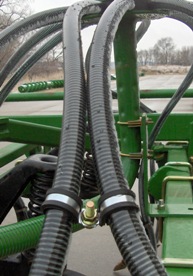 Clamps secure secondary air hose
Clamps secure secondary air hose
Consistent seed and fertilizer delivery to the opener depends on proper secondary air hose routing. John Deere has adopted innovative clamping methods to ensure hoses maintain their shape and stay clear of frame components that could potentially cause premature wear.
High-productivity sweeps
 High-productivity bolt-on sweep
High-productivity bolt-on sweep
 High-productivity Perma-Loc™ sweep
High-productivity Perma-Loc™ sweep
The high-productivity sweep from John Deere was developed to meet current tillage practices and compete in the high-productivity, high working speed market. Thanks to its low profile, curved wing shape, the high-productivity sweep:
- Performs best at a speed of 11.3 km/h to 16.1 km/h (7 mph to 10 mph)
- Easily moves through tougher and higher volume residue
- Retains its shape and width during its wear life
- Wear life is longer than Tru-Width™ sweeps and equal or better than competitors
- Excellent weed control performance
The high-productivity sweeps for the John Deere 1830 Air Hoe Drill comes in 178-mm (7-in.), 229-mm (9-in.), and 254-mm (10-in.), and 305-mm (12-in.) widths, both in the bolt-on and the Perma-Loc version. They fit all 47-degree standards with 44.5-mm (1.75-in.) hole spacing and 11.1-mm (7/16-in.) that currently take Tru-Width sweeps, both John Deere and other makes.
The high-productivity Perma-Loc style sweeps use the current Perma-Loc adapter for 47-degree curved standard N237614. Tru-Width sweeps with the Perma-Loc adapter can seamlessly move the high-productivity sweeps.
The high-productivity sweep also exerts less draft than Tru-Width and major competitors, reducing engine horsepower requirements and diesel consumption.
Features
Double-disk openers offer precise depth
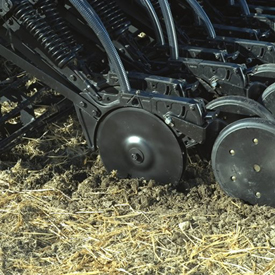 Leading edge cuts through moderate residue levels
Leading edge cuts through moderate residue levels
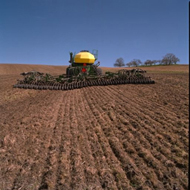 Narrow disk angle leaves smooth field finish
Narrow disk angle leaves smooth field finish
The 34.3-cm (13.5-in.) diameter double-disk openers are offset to create a narrow furrow for optimal seed placement. They feature aluminum boots and have a long-arm/short-arm stagger for residue clearance. Either 15.2-cm (6-in.) or 19-cm (7.5-in.) row spacing is available.
NOTE: 15.2-cm (6-in.) spacing is not recommended for heavy, sticky soils such as the Red River Valley of the North.
The 6-mm (1/4-in.) offset creates a leading edge and pinch point that is close to the soil surface for optimal penetration and residue cutting. Alternating of the blades with right and left leading edge prevents side drafting and leaves the field smooth with minimal soil throw.
Depth-gauging press wheels offer accurate seed placement
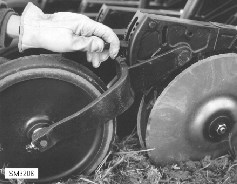 Individual press wheel depth adjustment
Individual press wheel depth adjustment

Depth-gauging press wheels:
- Allow quick, easy opener depth control
- Assist in controlling furrow depth
- Promote positive seed-to-soil contact for good germination
- Adjustments can be made from 0 cm (0 in.) to 9 cm (3.5 in.) by increments of 6 mm (1/4 in.)
5-cm x 33-cm (2-in. x 13-in.) press wheels are available on the 730
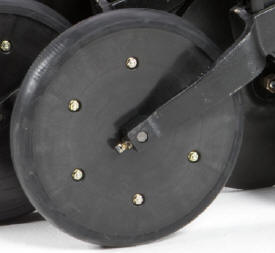 5-cm x 33-cm (2-in. x 13-in.) press wheel
5-cm x 33-cm (2-in. x 13-in.) press wheel
 5-cm x 33-cm (2-in. x 13-in.) press wheel
5-cm x 33-cm (2-in. x 13-in.) press wheel
For 15.2-cm (6-in.) row spacing:
- 5-cm (2-in.) x 33-cm (13-in.) (A) (standard equipment)
NOTE: 15.2-cm (6-in.) row spacing is not recommended for high-residue conditions or sticky soils like in the Red River Valley of the North.
For 19-cm (7.5-in.) row spacing:
- 5-cm (2-in.) x 33-cm (13-in.) (A) (standard equipment)
730 Level-Lift™ frame handles moderate residue with faster working speeds and consistent depth control
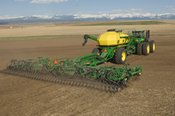 730 Level-Lift tilling, fertilizing, and seeding
730 Level-Lift tilling, fertilizing, and seeding

The 730 Level-Lift Air Disk Drill frame is very similar to the 2210 Level-Lift Field Cultivator. The 730 LL Air Disk Drill is a secondary tillage and seeding tool, an industry exclusive from John Deere. This frame is designed to offer durable support for the double disk openers while providing flexibility over level to gently rolling terrain.
Frame components include:
- Front-mounted rockshaft
- Tube-Thru-Tube frame
- Hose and wiring harness support and protection
Faster working speeds and consistent depth are results of the above features.
The 730 Level-Lift frames are:
- Constructed of continuous five-bar Tube-Thru-Tube frame
- 10.2-cm x 10.2-cm (4-in. x 4-in.) cross members
- 7.6-cm x 15.2-cm (3-in. x 6-in.) centerframe hitch tubes
- 5-cm x 12.7-cm (2-in. x 5-in.) end tubes
The large frame member sizes, joint welds, and the wheel module placement add to the structural integrity, providing stable, consistent front-to-rear and side-to-side operation.
The frame:
- Is 3.4-m (11.2-ft) deep frame (fore-aft)
- Has 61-cm (24-in.) under-frame clearance
- Can handle residue amounts of up to 40 percent
The wings flex 7 degree up and down. They fold over center for a compact transport or storage profile.
The front-mounted rockshaft:
- Offers superior front-frame strength for unmatched side-to-side levelness
- Provides torsional rigidity for the hydraulic system
- Opens up the frame for true shank placement, improving overall residue flow
The TruPosition™ shanks have a trip force at 90.7 kg (200 lb) and a 25.4-cm (10-in.) trip height.
Manually steer using a simple user interface
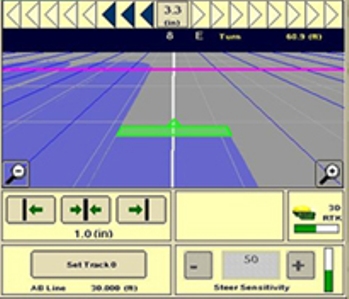 Manual guidance
Manual guidance

Manual guidance allows operators to manually steer by matching the machine icon with the line on the screen or by using the path accuracy indicator at the top of the guidance view screen.
Features
SeedStar™ 4HP monitoring system
SeedStar 4HP is designed to optimize the in-cab monitoring experience exclusively on the Gen 4 4600 CommandCenter™ display or 4640 Universal Display for growers with ExactEmerge™ planters and MaxEmerge™ 5e planters model year 2018 and newer. With SeedStar 4HP, operators will easily see key planter information with customizable run pages, zoom functionality, and simultaneous graph and performance measurements. SeedStar 4HP is included in base on all model year 2018 ExactEmerge and MaxEmerge 5e planters.
Features overview:
- View multiple planters' at-a-glance bar charts simultaneously
- Three default planter run pages show key planter functions in easy-to-view layouts
- Highly configurable run pages allow SeedStar modules to be customizable
- Zoom feature allows quick row-by-row detailed information
- View dual bar graphs to see multiple planter details at one time
- SeedStar application to make adjustments to planter functions
- Simplified setup through the work set-up page
- Custom rates allow up to six different rates across 48 rows
- The SeedStar 4HP monitoring system requires the Gen 4 4600 CommandCenter or 4640 Universal Display. These displays allow the operator to benefit from the updated interface, enhanced processing speeds, and easy setup (learn more here).
SeedStar 3 HP conversion to SeedStar 4HP with mobile row-unit runoff aftermarket for field conversion kits
Growers who are currently running model year 2017 planters, model year 2017 and newer retrofit kits, or model year 2017 and newer custom-built planters with the SeedStar 3 HP monitoring system can upgrade to the SeedStar 4HP monitoring system with mobile row-unit runoff. The attachment part, AA100382, is software only. The Gen 4 display software version will need to be 19-1 or newer and will require planter apps. Follow the mobile runoff ordering and software push guide below for ordering and installation. Retrofitted planters and custom-built planters will also require the John Deere Connect Mobile kit, 0048PC, from the Precision Ag Technology Price Pages and wiring harness AA83662 to enable the mobile row-unit runoff feature. Please reference Parts Advisor and CCMS Solution 105181 for model-specific mounting brackets. SeedStar 4HP requires the Gen 4 4600 CommandCenter™ v2 display or 4640 Universal Display.
Default planter run pages
 Planter summary default run page
Planter summary default run page
 Planter overview default run page
Planter overview default run page
 Planter details default run page
Planter details default run page
Three default run pages show key planter functions in different views to give fast and easy access to important planter information.
Custom run pages
 Customizable run pages
Customizable run pages
There are customizable run pages that allow the operator to build pages that fit their operation with different modules, like the example shown above.
Zoom functionality
 Zoom feature showing a group of rows
Zoom feature showing a group of rows
 Zoom feature showing a single row
Zoom feature showing a single row
The zoom feature allows the operator to touch a section or row of the planter and get detailed information quickly.
Dual bar graphs
 Dual bar graph showing singulation and population simultaneously
Dual bar graph showing singulation and population simultaneously
Dual bar graphs allow operators to view multiple planter details at one time.
Additional information
For additional information on feature functionality on the Gen 4 Display, visit the links below:
YouTube is a trademark of Google LLC.
SeedStar application page
 SeedStar application run page
SeedStar application run page
In the SeedStar application, many adjustments can be made, including manually activating section control. SeedStar 4HP allows up to 48 individual row sections. There are several setup features such as crop, seed disk, number of rows being planted, population alarms, and limits. Seed rates can be modified, electric power generation (EPG) can be turned on or off, vacuum can be adjusted, and the fill and purge functions can be used from the SeedStar application. Frame control, as well as diagnostics and calibrations, can be accessed at the bottom of the screen.
Settings Manager in SeedStar 4HP
 Settings Manager screens
Settings Manager screens

Reduce set-up time between changing crops or field conditions by recalling saved settings used previously with Settings Manager, included with every SeedStar 4HP system. This feature allows saving and recalling planter and tractor settings for optimum performance in different conditions.
Settings Manager can be used to save all of the adjustment and inputs associated to a particular crop or condition. An example would be to store all population rates, downforce pressure, row cleaner adjustments, and closing wheel settings for planting corn and storing a separate, unique set of adjustments for soybeans. In addition, Settings Manager stores tractor settings such as selective control valve (SCV) flow and detents, infinitely variable transmission (IVT™) settings, eco modes, and more.
Custom rates in SeedStar 4HP
 Variety set-up page
Variety set-up page
 Rate set-up page
Rate set-up page
 Group rate set-up page
Group rate set-up page
Custom rates allow for individual row population control and row-by-row documentation where up to six different rates can be assigned across an up to 48-row planter. This allows growers interested in planting seed corn with ExactEmerge or MaxEmerge 5e the capability to assign specific populations to male and female rows for planting. This feature can also be used to create tram lines or other applications where custom rates by row are needed.
NOTE: Individual rates are tied to varieties, so each individual rate needs a unique variety name.
Compatibility
| SeedStar 4HP compatibility | |
| Planters | All models ordered with ExactEmerge or MaxEmerge 5e row-units NOTE: Retrofit kits are equipped with SeedStar 3HP only, but can be upgraded by purchasing part number AA100382. |
| Displays | Gen 4 4600 CommandCenter equipped with Version 2 Processor or 4640 Universal Display Dual-display mode is compatible with mid model year 2019 planter software. |
| Active Implement Guidance (AIG) | Compatible with SeedStar 4HP on Gen 4 displays with VT mode and required activations and subscriptions |
| AutoTrac™ Implement Guidance | Not compatible |
| AutoTrac Turn Automation | Not compatible |
Downforce system options

Heavy-duty adjustable downforce springs
 Heavy-duty adjustable downforce spring
Heavy-duty adjustable downforce spring
Planter row-unit downforce is an important factor to ensure consistent and proper depth control. The heavy-duty adjustable downforce feature provides up to 181.4 kg (400 lb) of downforce. There are four settings available to allow the operator to choose the amount of downforce required for the condition: 0 kg (0 lb), 56.7 kg (125 lb), 113.4 kg (250 lb), and 181.4 kg (400 lb).
Compatibility: 1705, 1715, 1725, 1735, 1755, 1765, 1765NT, 1775 Flex, and 1785
Standard pneumatic downforce system
Pneumatic downforce provides convenient, simple adjustment of downforce for the whole planter from one location. The amount of downforce applied is infinitely adjustable from 0 to 181.4 kg (0 to 400 lb). Pneumatic downforce provides more consistent downforce throughout the range of row-unit travel than mechanical spring downforce systems.
Features include:
- 9.5-mm (3/8-in.) air delivery line instead of the 6.4-mm (1/4-in.) line used on model year 2010 and older planters.
- Air compressor assembly increased duty cycle. With this compressor, it provides a 47 percent increase in maximum air flow delivery compared to the prior air compressor.
- Pneumatic air bags with 9.5-mm (3/8-in.) air line inlets that have greater durability.
 Pneumatic downforce spring
Pneumatic downforce spring
Each row-unit has a single rubber air bag located between the parallel arms. The air bags are hooked in parallel so that air can be added or released from all rows at once from one location.
The individual pneumatic downforce air bag assemblies, air compressor units, and 9.5-mm (3/8-in.) delivery lines are also available as an attachment for field conversion.
 Pneumatic downforce compressor and gauge
Pneumatic downforce compressor and gauge
An improved compressor is used to charge the pneumatic system. This compressor can be located on the planter frame or in the tractor cab if desired. A gauge at the compressor indicates the amount of downforce being applied.
From the factory, integral planter models with pneumatic downforce will have an improved air compressor assembly with an in-cab mounting bracket, except for the 1725 16-row and 1725 Central Commodity System (CCS™) twin-row planters, which will have the air compressor assembly mounted on the planter frame. For drawn planter models, the 1755, 1765, 1765NT, 1775 Front-Fold, and 1785 Drawn Planters will have the air compressor assembly installed either on the outer hitch or wing frame members when the pneumatic downforce system is installed.
Base equipment on: 1705, 1715, 1725, 1735, 1755, 1765, 1765NT, 1775 and 1785.
Integrated pneumatic downforce system
The functional features of the integrated system are the same as the standard pneumatic system, explained above, with the addition of control through the GreenStar™ display.
SeedStar XP row-unit downforce planter run page
 SeedStar XP downforce planter run page
SeedStar XP downforce planter run page
Active downforce control is integrated into SeedStar XP and SeedStar 3 HP monitoring systems.
Margin is the amount of weight riding on the depth gauge wheels that ensures desired firming of the seedbed as set by the operator.
Once a target margin has been defined, enter the value into SeedStar XP or SeedStar 3 HP and let active downforce do the rest. The system will actively adjust the air pressure in the air bags to maintain a constant margin across the planter. The changes in air pressure will change the amount of downforce placed on the row-unit, compensating and reacting for varying conditions through the field whether it is different tillage practices, soil types, or moisture.
System control with the GreenStar display
 Pneumatic downforce control in GreenStar 2 Display
Pneumatic downforce control in GreenStar 2 Display
 Air compressor mounted on 1775NT outer hitch
Air compressor mounted on 1775NT outer hitch
On 1725 16-row, 1725 CCS TR, 1775NT, 1775NT CCS, 1795, DR, and DB Series Planter models, the air compressor will be mounted on the outer hitch or frame assembly. Since the air compressor assembly is mounted on the outer hitch (as noted in the picture above) or frame, adjustments for row-unit downforce and related system pressures will be made electronically with the GreenStar display.
When adjusting the amount of row-unit downforce using the GreenStar display, the operator will select the amount of downforce (kg [lb]) to be applied across the planter. Depending on the soil conditions at hand, the operator might need to adjust the relative amount of row-unit downforce being applied during the planting operation. The integrated pneumatic downforce controls within the GreenStar display will only allow for set-point operation and not automatic control as the planter is operating in different soil conditions. The pneumatic downforce system does not have the capability to automatically adjust downforce.
On-board air storage
 Onboard air storage installed on 1775NT 24R30
Onboard air storage installed on 1775NT 24R30
The 1725 16-row, 1725 CCS TR, 1775NT, 1775NT CCS, 1795, DR, and DB Series planters will have onboard air storage to increase the overall response time when making a row-unit downforce adjustment from the GreenStar display. The onboard air storage is comprised of a 18.9-L (5-gal.) storage tank with valve assembly.
Base equipment on: 1725 CCS, 1725 16-row, 1725T, 1775NT, 1775NT CCS, 1795, DR, and DB Series Planters with MaxEmerge™ 5 row-units. MaxEmerge 5e and ExactEmerge™ equipped planters come with active pneumatic downforce in base.
Active pneumatic downforce
 Active downforce compressor assembly
Active downforce compressor assembly
 Hydraulic motor
Hydraulic motor
A hydraulically driven compressor works with the SeedStar™ 3 HP system and SeedStar XP system to automate downforce control. Just set the row-unit target margin value and the active pneumatic downforce system works automatically. The system will make sure the planter maintains this value, achieving precise soil penetration, and consistent planting depth, without sidewall soil compaction. From the factory, the system is set at 45.4 kg (100 lb) target downforce margin, but may be modified for varying field conditions. This frees the operator from constantly making manual downforce adjustments as conditions change.
This system offers a split-rank control feature for 1795 and DB Split-Row Planters. On split-row planters, active downforce will control the front and rear rows independently. This compensates for differing downforce requirements between the ranks that can be caused by things like different tillage or insecticide attachments and will help maintain an accurate planting depth and consistent margin across all the rows.
Active pneumatic downforce is available as factory installed or as an attachment for field conversion.
 IRHD screen showing the ground contact graph
IRHD screen showing the ground contact graph
 IRHD screen showing the applied downforce graph
IRHD screen showing the applied downforce graph
Optional equipment on: 1775NT, 1795, DB, and Orthman custom models with MaxEmerge 5e and ExactEmerge row-units.
 Downforce and margin example
Downforce and margin example
- A - Margin – amount of additional downforce applied to a row-unit above and beyond what is required for penetration to achieve planting depth. This additional weight will ride on the depth gauge wheels. 54.4 kg (120 lb) + 36.3 kg (80 lb) = 90.7 kg (200 lb) – 68 kg (150 lb) = 22.7 kg (50 lb) of margin
- B - Weight of row-unit - 54.4 kg (120 lb)
- C - Downforce – force that is applied to the row-unit by the air bag circuit - 36.3 kg (80 lb)
- D - Resistance from soil - 68 kg (150 lb)
Hydraulically driven compressor
 Hydraulic motor
Hydraulic motor
 Pneumatic valve
Pneumatic valve
The hydraulically driven air compressor can deliver up to eight times the air flow, allowing for more and faster downforce changes to be made. This more robust design features a 37.8-L (10-gal.) storage tank across all models with active downforce.
At approximately 15.1 L/min (4 gpm), hydraulic demands are low and ties into the machine’s lift and CCS hydraulic circuit so it does not require any additional selective control valves (SCVs). The SeedStar XP and SeedStar 3 HP monitoring systems work with the compressor and valve assembly to regulate air to downforce springs, enabling the active control.
Another feature of John Deere active downforce is the ability for the pneumatic valve to independently control split-rank machines. This system senses the downforce needs from the front and rear ranks separately and independently adjusts air pressures with the dual-rank pneumatic valve when equipped. Active pneumatic downforce requires SeedStar XP or SeedStar 3 HP to enable active control.
Base equipment on: All MaxEmerge 5e and ExactEmerge equipped planter models.
Individual Row Hydraulic Downforce (IRHD)

IRHD has been specifically designed to meet the needs of producers that are looking to adjust to the toughest field conditions and provide maximum yield potential from field to field, season after season. IRHD works as a closed-loop downforce system that reacts quickly on an individual row basis to changing soil conditions supporting increased ground contact, which can lead to improved seed depth consistency. When setting planter downforce margin, the system will apply the needed downforce by row to maintain ground contact. From the factory, the margin will be set at 45.4 kg (100 lb), changes may be required based on varying field conditions.
The system allows operators to maintain gauge wheel ground contact leading to desired seed depth placement. IRHD can adjust five times per second and make adjustments of 45.4 kg (100 lb) in less than a second. The system has a total range of applied downforce from 22.7 kg (50 lb) to 204.1 kg (450 lb) and utilizes the power beyond circuit on the tractor. IRHD is 58 percent faster than the active pneumatic downforce solution. Fast reaction and increased ground contact can lead to improved emergence. With uniform emergence, some studies have shown a yield impact from 5 percent to 9 percent.
IRHD is controlled through the Gen 4 4600 CommandCenter™ Display or 4640 Universal Display with SeedStar 4HP. As shown below, operators can view ground contact or applied downforce using the toggle button.
Pneumatic closing wheels

Pneumatic closing wheels are compatible with MaxEmerge™ 5e and ExactEmerge™ row-units. They are available on the following models from the factory: 1775NT, 1795, and DB60 models. The pneumatic closing wheels give operators the ability to adjust closing wheels in seconds without leaving the cab of the tractor.
Using the GreenStar™ 3 2630 Display, pneumatic closing wheels can be adjusted to 25 different positions. From the factory the system is setup with two sections, the outer wings and center frame. With this system, producers will see up to a 76 percent increase in consistent force applied at the closing wheel. Consistently applying the correct force at the seed trench is one of the key elements of supporting improved emergence. Studies show potential yield impact on corn from even emergence from 5 percent to 9 percent*.
NOTE: Pneumatic closing wheels can be purchased for existing MaxEmerge 5e and ExactEmerge planters as an aftermarket field kit. Both rubber tire and cast-iron closing wheels are compatible.
Access the pneumatic closing wheels attachment for field conversion (AFC) ordering guide to fit a 1725 CCS, 1775NT, 1795, or DB60 Planter.
*Planting Outcome Effects on Corn Yield: Doerge, Tom, Jeschke, Mark and Carter, Paul
Easy Adjust row cleaners
 Coulter combo row cleaner
Coulter combo row cleaner
 Easy Adjust row cleaner
Easy Adjust row cleaner
Easy Adjust row cleaner and coulter combo provides a pneumatic row tillage solution that is controlled from the seat of the tractor.
Every decision to make an adjustment during spring planting reduces the acres planted per day and can increase or decrease profitability. An adjustment that can be overlooked is row cleaners due to planter size, difficulty to make the adjustment, and varying conditions across fields and time.
 GreenStar™ 3 2630 Display view for row cleaners compatible with SeedStar™ 3 HP
GreenStar™ 3 2630 Display view for row cleaners compatible with SeedStar™ 3 HP
 4600 CommandCenter™ Display and 4640 Universal Display view for row cleaners compatible with SeedStar 4HP
4600 CommandCenter™ Display and 4640 Universal Display view for row cleaners compatible with SeedStar 4HP
With the Easy Adjust row cleaners on ExactEmerge™ planters, operators now have a pneumatic solution to make on-the-go adjustments that is controlled directly from the seat of the cab. They can be raised from the cab as needed with the push of a button for wet areas, waterways, or end rows. For growers using SeedStar 3 HP, the row cleaners are completely integrated into the John Deere GreenStar 3 2630 Display as well as the Gen 4 4600 CommandCenter display or 4640 Universal Display. For growers using SeedStar 4HP, a 4600 CommandCenter display or 4640 Universal Display is required.
The Easy Adjust row cleaners have the capability to save three presets for varying ground engagement based on field conditions. The system is controlled in three sections: at each wing as well as the center (frame or wheel) track rows. The pneumatic lines use air from the active pneumatic downforce compressor, requiring no additional compressor to be installed on the planter. The Easy Adjust row cleaners utilize down and up force air bags. The adjustable air pressure setting for each bag allows the operator to set the ride of the row cleaner depending on the field conditions and the desired results. Making these on-the-go adjustments from tractor cab increases productivity and performance during planting.
For Easy Adjust row cleaner performance upgrade kit options, see the ordering guide.
The row cleaner-only option utilizes parallel linkage to provide the floating action growers require in their fields. Parallel linkage allows for the unit to float up and down in the situation of hills or hard objects. The cleaner and coulter combo does not have parallel linkage, however, the row cleaners have floating rings installed to help provide the same benefits.
The row cleaners utilize the field-proven SharkTooth® design. Row cleaners play a major role in maximizing yield toward uniform emergence, reducing row-unit bounce, and maintaining proper depth. The Easy Adjust row cleaners provide growers with quick and stress-free solutions to customizing the planter in variable field conditions. They are available on ExactEmerge and MaxEmerge 5e equipped planters. They are not integrated into the RowCommand™ feature.
SharkTooth is a trademark of Yetter Manufacturing Incorporated.
Vacuum automation
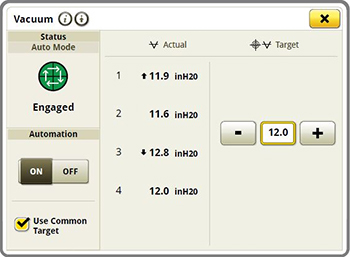 Vacuum automation screen
Vacuum automation screen
Vacuum control has been defined. Before vacuum automation, an operator set the vacuum level by adjusting the hydraulic flow through each selective control valve (SCV). Many variables altered the vacuum level while the hydraulic flow stayed constant. This could have resulted in under or over populating, which may have impacted singulation. With vacuum automation, all that needs to be done is set the desired vacuum level and let the monitor do the work of adjusting the hydraulic flow. Should vacuum changes occur, the software in the monitor will fluctuate the SCV flow to achieve the desired vacuum level.
Vacuum automation requires SeedStar™ 4HP monitoring. The system controls SCV flow based on the vacuum pressure sensor. The tractor must be a John Deere with Tractor Electronic Control Unit (TECU) 3 controller area network (CAN) system for this feature to be compatible. The vacuum automation feature will control all vacuum fans if they are on their own SCVs. More vacuum fans make the planter more valuable and easier to operate.
Vacuum automation is not compatible with Interim Tier 4 (IT4) 6R Series Tractors.
Increase productivity with ExactEmerge™ trench delivery system and BrushBelt™ delivery system
It is very challenging to get the crop planted during the optimum planting window or as close to the optimum planting day as possible. Rate-of-yield loss accelerates greatly after the optimum window has passed. This is especially true in the northern U.S. and Canada. ExactEmerge maintains accurate speed placement at higher speeds; growers can avoid missing that peak planting time, thereby helping to get the highest crop yields.
 Yield loss after optimum planting day
Yield loss after optimum planting day

With the BrushBelt trench delivery system, the spacing in the trench does not change from even to uneven terrain. This can be a problem with a traditional seed tubes. Seed bounce and ricochet may occur as slopes increases, ultimately decreasing seed spacing performance.
The design of the BrushBelt system provides the best solution for the lowest release of seed to the bottom of the trench. The use of a brush provides the meter with an infinite amount of placement opportunities for each seed. This is what gives producers the confidence that every seed will have the desired spacing that a seed tube cannot provide.
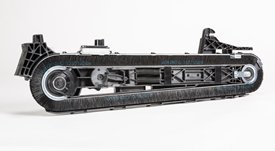 Maintenance-free BrushBelt system
Maintenance-free BrushBelt system

When the brush comes around the pulley, it expands and allows the seed to be transferred from the bowl to the brush very easily. The brush then carries the seed down toward the trench, ensuring that there is no movement as it moves down the length of the cartridge.
Once the brush reaches the lower pulley, the BrushBelt system expands again to loosen the grip on the seed, and the centrifugal force releases the seed. Another advantage with the BrushBelt system and cartridge at all speeds up to 10 mph is the ability to match the seed rearward trajectory to the forward ground speed of the planter. This provides a dead drop of the seed with no bounce and no roll at the bottom of the trench.
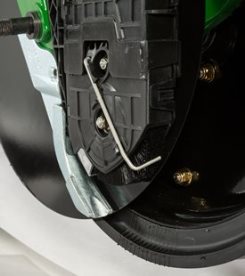 BrushBelt conditioner engages brush bristles
BrushBelt conditioner engages brush bristles

John Deere’s ExactEmerge cartridge is self-cleaning. When an operator uses seed treatments or is forced to plant in less than ideal soil conditions, the design of the trench delivery system sheds buildup from the BrushBelt. A brush conditioner is located at the bottom of the cartridge to remove remaining residue and prevent the bristles from sticking together.
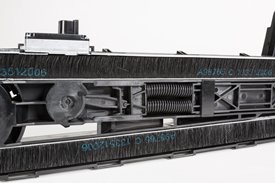 Brush proximity helps clean sensor
Brush proximity helps clean sensor

Another advantage over a seed tube is that the BrushBelt system also acts as a cleaner to the seed sensor compared to a seed tube.
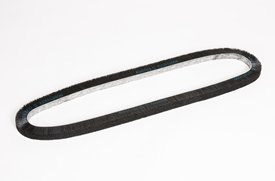 BrushBelt removed from trench delivery system
BrushBelt removed from trench delivery system

The BrushBelt system requires no maintenance and has a wear life designed to match the wear life of the other wear components. Since operations vary, as do soils and field content, it is recommended to replace the BrushBelt after noticeable wear or decreased performance.
Changing the belt is easy. One latch removes the meter over the trench delivery system. Grab the cartridge by the grip and pull toward the body, releasing it from the electric motor fitting. Lift the trench delivery system up and remove the sensor wiring harness to completely pull the cartridge out of the row-unit.
There are two plastic covers that snap off to uncover the belt; remove the covers and then twist the circular spring-tensioner dial with the yellow arrow on it to release the tension on the springs. Once tension has been removed, pull the belt out. It is also recommended to change the stainless-steel wear strip at this time as well, which also slides right out of place without the use of tools.
NOTE: It is recommended to use a talc/graphite mixture with ExactEmerge. Best results have been 80 percent talc and 20 percent graphite. For certain regions and territories, talc and talc/graphite mixes are restricted from use; in this case, use a wax-based fluency agent.
MaxEmerge™ 5e overview
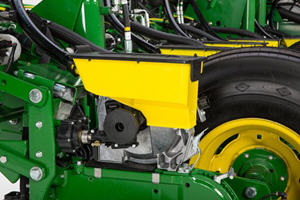
The MaxEmerge 5e is designed to improve population accuracy, spacing, and avoid wasting inputs for maximizing yield. The "e" in MaxEmerge 5e stands for electric drive. It is driven by one electric motor per meter with a small controller. This does away with the shafts and drivelines of a typical mechanical drive. That means more reliability, less maintenance, and easier access to row-unit components. For producers who want uniform seed spacing, the MaxEmerge 5e is a great option.
One of the biggest advantages of the MaxEmerge 5e is how it improves population accuracy by compensating for curves on the outer rows of the planter. The MaxEmerge 5e row-unit eliminates shafts and drivelines from the planter, allowing better access to row-unit components and decreased planter maintenance. Additionally, the MaxEmerge 5e allows corn and soybean growers to achieve up to a 20 percent improvement in population accuracy on the outer rows of a 24-row planter while planting on curves utilizing curve compensation.
While the MaxEmerge 5e uses a seed tube, it offers some of the same important advantages as ExactEmerge row units. The MaxEmerge 5e also improves reaction to population changes in the field when conditions dictate a higher or lower population, enabling producers to more accurately plant to the variable-rate prescription that maximizes profit potential. High-performance vacuum automation automatically maintains the target vacuum setting throughout the day with less time monitoring and making adjustments. It uses the SeedStar™ 4HP system and is compatible with Connect Mobile monitoring for near real-time, row-by-row planting performance. Depending on planter model, the MaxEmerge 5e package unlocks additional options like easy adjust row cleaners, Individual Row Hydraulic Downforce (IFHD), and pneumatic closing wheels.
The MaxEmerge 5e delivery system options include mini-hoppers with Central Commodity System (CCS™), 56.4-L (1.6-bu) hoppers, and 105.7-L (3-bu) hoppers.
NOTE: MaxEmerge 5e row-units are compatible with the following models: 1725NT, 1725C, 1725 CCS (not available on twin row), 1775NT, 1795, DB44, DB60, DB66, DB80, DB88, and DB90 (not available on 54R 50.8 cm [20 in.]).
RowCommand™ individual-row control system
RowCommand controls seed output
 RowCommand on a MaxEmerge™ 5 row-unit
RowCommand on a MaxEmerge™ 5 row-unit
 RowCommand on a chain drive MaxEmerge 5 row-unit
RowCommand on a chain drive MaxEmerge 5 row-unit
Controlling input costs and improving productivity are key producer requirements today. RowCommand is an effective, integrated John Deere solution designed to meet these intensifying needs. The RowCommand system manages seed output, reduces yield drag, and improves harvest capabilities on all Pro-Shaft™ driven row-units, and chain-driven MaxEmerge 5.
NOTE: Chain-drive RowCommand is only compatible with planters equipped with pneumatic downforce systems. On planters equipped with the heavy-duty downforce springs, potential chain interference may result and is not recommended.
NOTE: Chain-drive RowCommand requires some modification to brackets in order to function with corn finger pickup meters.
NOTE: Pro-Shaft drive RowCommand is compatible on MaxEmerge 5 row-units with vacuum and corn finger pickup meters. For mini-hopper row-units, RowCommand is compatible on vacuum meters only and is not compatible on corn finger pickup meters. Pro-Series™ XP row-units with corn finger pickup meters are not compatible with RowCommand.
RowCommand controls seed output by incorporating individual, low amperage clutches inside the Pro-Shaft and chain-driven gearboxes. Clutches are completely enclosed within the gearbox housing to protect them from the elements and harsh operating conditions.
When power is supplied, either manually or through John Deere Section Control software, clutches disengage the seed meters and seed flow stops. Controlling seed output at individual rows reduces overplanting in point rows and maximizes seed placement when entering/exiting headlands.
Components and operation
 Electronic power modules shown on a 1775NT Planter
Electronic power modules shown on a 1775NT Planter
 RowCommand clutch on MaxEmerge 5 with 105.7-L (3-bu) hopper
RowCommand clutch on MaxEmerge 5 with 105.7-L (3-bu) hopper
RowCommand is a simple and efficient solution to control individual row planting. This system does not utilize air to operate; therefore, no compressor, air lines, or valve modules are required.
RowCommand utilizes low-voltage controller area network (CAN) messaging to signal power to the desired clutches to stop planting or eliminates power to resume planting.
This means very little power is used in normal planting conditions, and in the event a clutch fails electrically, the meter will continue to plant.
The RowCommand system requires the following five basic components to operate:
-
Electric clutches
-
Electronic power modules (EPMs)
-
SeedStar™ 2 monitoring (wedge box/controller)
-
GreenStar™ (GS) display
-
Planter wiring harnesses
Clutches are protected within the sealed Pro-Shaft and chain-driven gearboxes for years of trouble-free operation and simple installation or removal. RowCommand has true individual-row control of up to 16 clutches or sections for planters larger than 16 rows.
Unique to RowCommand, the 16 available control sections can be configured based on operator preferences. For example, on a 1775NT 24-Row Planter, every two rows can be paired together for a total of 12 control sections, or control the outermost eight rows individually and the remaining inner rows paired together for 16 control sections.
While SeedStar with RowCommand has 16 control sections, a minimum of 152.4-cm (60-in.) wide sections are recommended for optimum Swath Control Pro™ solution capabilities. As with other Swath Control Pro products, an SF2 signal is the minimum level of accuracy recommend for operation.
Integrated Swath Control Pro
Coupling RowCommand with Swath Control Pro provides the ultimate in precision planting and productivity. One company, one integrated solution are what we offer by incorporating Swath Control Pro capabilities within the SeedStar 2 wedge box (controller). Unlike previous systems, no rate controller, additional harnessing, or components are required to achieve automated individual-row control.
SeedStar 2 monitoring, RowCommand, and Swath Control Pro activation from John Deere Precision Ag Technologies are all that is needed when ordering.
Pro-Shaft drive RowCommand planters
RowCommand is available as a factory-installed option or as an attachment for field conversion attachments for the following Pro-Shaft drive planter models (see chart below).
| Planter model | Row configuration |
| 1725 | 12-row narrow, 12-row wide, and 16-row narrow |
| 1725 Central Commodity System (CCS™) | 16-row narrow |
| 1765 | 12-row narrow |
| 1775 | 12-row narrow |
| 1775NT | 12 row, 16 row, and 24-row narrow |
| 1775NT CCS | 12 row, 16 row, and 24-row narrow |
| 1795 | 12/23 row, 12/24 row, 16/31 row, and 16/32 row |
| 1795 | 24 row, 50.8 cm (20 in.) |
| DB 44 | 24 row, 55.9 cm (22 in.) |
| DB 58 | 32 row, 55.9 cm (22 in.) |
| DB 60 | 36 row, 50.8 cm (20 in.) or 47 row, 38.1 cm (15 in.) |
| DB 66 | 36 row, 55.9 cm (22 in.) |
| DB 80 | 32 row, 76.2 cm (30 in.) or 48 row, 50.8 cm (20 in.) |
| DB 88 | 48 row, 55.9 cm (22 in.) |
| DB 90 | 36 row, 76.2 cm (30 in.) |
| DB 120 | 48 row, 76.2 cm (30 in.) |
| DR (Deere/Orthman™ planter) 16R40 | 16 row, 101.6 cm (40 in.) |
| DR (Deere/Orthman) 18R38 | 18 row, 96.5 cm (38 in.) |
Chain-drive RowCommand planters
In terms of planter compatibility, RowCommand for chain drive is designed for the following planter model configurations equipped with pneumatic downforce systems.
| Planter model | Row configuration |
| 1725 | 12-row narrow, 12-row wide, and 16-row narrow |
| 1765 | 12-row narrow |
| 1775 | 12-row narrow |
| 1775NT | 12 row and 16 row |
| 1775NT CCS | 12 row and 16 row |
| DB 44 | 24 row, 55.9 cm (22 in.) |
Chain-drive RowCommand and heavy-duty downforce
 Chain interference with heavy-duty downforce
Chain interference with heavy-duty downforce
As seen in the image, chain interference may result when operating chain-drive RowCommand on planters equipped with short and long parallel arms and heavy-duty downforce springs.
NOTE: Chain-drive RowCommand is only compatible with planters equipped with pneumatic downforce systems. On planters equipped with the heavy-duty downforce springs, potential chain interference may result and is not recommended.
Chain-drive RowCommand with corn finger pickup meters
 Bracket material removal
Bracket material removal
Due to the design characteristics of the chain-drive RowCommand clutch, some modification to the corn finger pickup meter drive bracket is required. As seen in the picture to the left, some material needs to be removed from the front of the meter drive bracket in order for the chain-drive RowCommand clutch to have sufficient space for installation.
NOTE: Chain-drive RowCommand requires some modification to brackets in order to function with corn finger pickup meters.
RowCommand ordering information
To add RowCommand to a model year 2009 and newer planter model listed above is simple. Pro-Shaft drive attachments for field conversion and chain-drive attachments for field conversion are available by planter model to add the appropriate number of clutches, EPMs, brackets, hardware and row-unit harnesses. For complete installation and part detail for the RowCommand conversion, please use the RowCommand compatibility tool per specific planter model.
RowCommand is compatible and available for model year 2003 (serial number 700101) to 2008 (725101) planter models listed above. In addition to the attachment for field conversion attachment, a planter mainframe harness, SeedStar 2 controller (wedge box), and additional CAN harnesses are needed.
System requirements
RowCommand is a simple and efficient means to control individual row planting through the use of low-voltage electric clutches. When activated, each clutch consumes no more than 0.5 amps. By design, power is only supplied to the clutch when a signal is received to stop planting. In a normal planting condition, no power is supplied and the clutch is de-energized.
Power for the RowCommand system is provided from the 9-pin ISO implement connector. All late-model 8X00 and 9X00 Series John Deere Tractors equipped with the 9-pin ISO implement connector are capable of supplying ample power for system operation.
Along with ample system power, a GreenStar display and SeedStar monitoring are required for operation and control interface. The GreenStar display is where system setup, control settings, and manual control functions are performed.
SeedStar™ 2 monitoring system
Integrated innovation is what operators will appreciate with the SeedStar 2 monitoring system and GreenStar™ 2 Display. An increasing number of acres combined with rising seed costs drive the need to easily understand planter functions and monitor performance. It is all about making every seed count and that is what SeedStar 2 delivers.
The SeedStar 2 monitoring system is a full-feature, color, seed population monitor used in conjunction with the GreenStar family of displays. SeedStar 2 is compatible with the GreenStar 2 1800 and 2600 Displays, GreenStar 3 2630 Display, the Gen 4 4200 CommandCenter™ Display, the Gen 4 4600 CommandCenter Display, the 4240 Universal Display, and the 4640 Universal Display. SeedStar 2 is not compatible with the Gen 4 Extended Monitor. Conveniently, SeedStar 2 planting functions are fully integrated with the full spectrum of Precision Ag Technology applications—guidance, coverage maps, and field documentation can be shown all on one display.
When a SeedStar 2 system is used on a planter, there is no need for a ComputerTrak™ monitor. All vital planting information is displayed in one central, easy-to-read location.
SeedStar 2 features
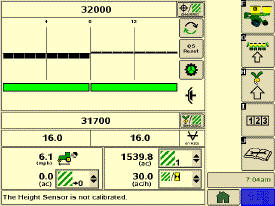 SeedStar 2 full-screen planter run page
SeedStar 2 full-screen planter run page
SeedStar 2 is a user-friendly system that has retained all the valued features of SeedStar and incorporated the next generation of enhancements. For example, on-screen color indicators show drive engagement/disengagement status. In addition, three color planter-at-a-glance bars (black, orange, or red) visually inform the operator of row population status.
Not only does SeedStar 2 incorporate the use of color, it also utilizes an intuitive icon and folder based operator interface. Icons are easy to understand across many languages and reduce the need for text. Icons for planter main run page, planter setup, seed/crop setup, totals, and diagnostics are located in the soft-key region of the display. Setup is performed by selecting the appropriate icon and then choosing the tabs to enter/select information.
The SeedStar 2 monitor offers all of the features and functionality of the ComputerTrak 350 monitor and much more. SeedStar 2 monitors the following planter functions:
- Row population/spacing
- Row failure
- Average population (entire planter and by variable-rate drive [VRD] motor section)
- Vacuum level
- Fertilizer pressure
- Acre counter
- Total acreage
- Tractor speed
In addition, planter operational information is available within the SeedStar 2 monitor system. Such operational information includes population charts, seed disk vacuum settings, and setting recommendations for the piston pump liquid fertilizer system.
All SeedStar 2 systems have the capability, through a single controller, to perform both the seed monitoring and variable rate drive functions. SeedStar 2 monitoring is required for VRD population control. Even though the planter may not be equipped with SeedStar 2 VRD, the SeedStar 2 monitoring system is available and will allow for future installation of VRD.
SeedStar 2 enhancements
 SeedStar 2 half-screen planter run page
SeedStar 2 half-screen planter run page
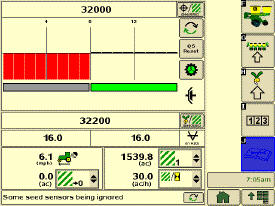 SeedStar 2 showing half-width disconnect status
SeedStar 2 showing half-width disconnect status
The SeedStar 2 enhanced planter features include:
- GreenStar 2 display integration – eliminates the need to operate the GreenStar 2 2600 Display in the original GreenStar monitor mode or the use of dual displays.
- User-friendly, intuitive icons
- Half- or full-screen run page
- On-screen, color drive status – a quick glance at the display tells the operator if the half-width disconnect is engaged or disengaged.
- Three-color planter-at-a-glance population bar – a black bar indicates that population is close to target and within established limits; orange shows the population is above/below the alarm set point; and red signals the population is out of operating range or is not planting.
- Three-piece, color VRD indicator – each piece of the VRD gear pie turns green when the wheel motion sensor is active, planter is lowered, and drives are engaged.
SeedStar monitoring original features
SeedStar 2 retains all those SeedStar features that producers value and have come to expect:
-
Planter at a glance – allows operator to view relative population levels of all rows on one screen.
-
Automatic valve calibration – with the SeedStar VRD, this is now completed automatically. There is no longer a need to manually calibrate the hydraulic valves.
-
Increased population updates – SeedStar will now update population levels once a second at planter start up then approximately once every three seconds.
-
Mapping of actual seed rates – When combined with Field Doc™ system, actual and target seeding rates can now be mapped in APEX™ software.
-
Reprogrammable utilizing controller area network (CAN) via Service ADVISOR™ diagnostics system.
-
Improved diagnostics/event recorder – on SeedStar VRD planters, additional diagnostic information is available, as well as an event recorder to capture system performance data at a specific point in time.
-
Ability to run motors at different population levels – on SeedStar VRD, operators running multiple motor systems can run each motor at a different speed, allowing different population levels within a planter.
-
User-configurable high fertilizer pressure alarm – allows the operator to be warned when fertilizer pressure reaches a specific level.
-
Automatic quick-start for SeedStar VRD – the operator no longer needs to press the quick-start button on end row turns to resume planting.
-
Automatic tractor speed source selection – when equipped with an 8000/9000 Series Tractor, the system selects the radar speed or allows for manual speed input selection.
SeedStar™ XP monitoring system
SeedStar XP overview
 SeedStar XP shown on the GreenStar™ 3 2630 Display
SeedStar XP shown on the GreenStar™ 3 2630 Display
 SeedStar XP shown on the GreenStar 2 1800 Display
SeedStar XP shown on the GreenStar 2 1800 Display
Building upon the foundation of SeedStar 2, the SeedStar XP system takes planter monitoring to the next level. SeedStar XP is compatible with the GreenStar 2 1800 and 2600 Displays, GreenStar 3 2630 Display, the Gen 4 4200 CommandCenter™ Display, the Gen 4 4600 CommandCenter Display, the 4240 Universal Display, and the 4640 Universal Display. SeedStar XP is not compatible with the Gen 4 Extended Monitor.
Specific information about how the planter is performing enables the operator to make needed adjustments for implement optimization.
The SeedStar XP planting functions are fully integrated with the full spectrum of Precision Ag Technology applications such as Swath Control Pro™ system for planters, GreenStar AutoTrac™ assisted steering system, John Deere Operations Center, Documentation, and others. Integrated planting technologies for better asset utilization and ease of use is just part of what SeedStar XP provides.
SeedStar XP seed singulation monitoring
 SeedStar XP seed singulation planter run page
SeedStar XP seed singulation planter run page
Understanding the meter singulation performance on the planter is critical to minimizing the amount of seed multiples and skips. As a result, the SeedStar XP monitoring system provides real-time information from the row-units about the overall seed singulation performance.
As seen in the screen shot image above, seed multiple information is displayed on the top portion of the planter-at-a-glance bar with seed skip information on the lower portion. This provides the operator a better understanding of relative seed multiple and skip data on a row-unit basis, all within one easy glance.
Also, within the seed singulation planter run page, information about row-units with the highest percentage of seed multiples and skips is provided in order to make necessary adjustments for better planter optimization.
SeedStar XP row-unit ride dynamics planter run page
 SeedStar XP ride dynamics planter run page
SeedStar XP ride dynamics planter run page
While operating a planter, travel speed and field conditions can affect the amount of row-unit bounce that is experienced. Excessive row-unit bounce or vertical motion can cause problems with meter performance. To better understand the amount of row-unit vertical motion when travelling through a field, the SeedStar XP monitoring system provides real-time information on row-unit ride dynamics.
As seen in the ride dynamics planter-at-a-glance screen shot image above, the SeedStar XP system provides ride dynamic information for each sensor node that is mounted on the planter. Each sensor node transmits ride dynamic information for each planter frame section to allow for the operator to make necessary operating adjustments to improve overall planting performance.
SeedStar XP row-unit downforce planter run page
 SeedStar XP downforce planter run page
SeedStar XP downforce planter run page
As row-unit downforce systems gradually change from heavy-duty downforce springs to pneumatic downforce, being able to understand the amount of as-applied row-unit downforce is needed while operating the planter.
With various soil conditions, moisture, etc. experienced while planting, it is imperative to have the ability to change actual row-unit downforce to have enough force for the Tru-Vee openers to penetrate the soil media. However, in some conditions, having too much downforce applied to the row-units for effective opener penetration could cause problems with side wall compaction from the gauge wheel.
Side wall compaction within the seed furrow can cause hatchet roots to develop, or roots that do not have the ability to penetrate the seed furrow soil media. This could lead to poor plant emergence and eventually lower overall yield performance.
With the SeedStar XP monitoring system, row-unit downforce information is measured by the downforce sensor and sensor nodes and transmitted to the GreenStar 2 Display in the tractor cab (as seen in the image above). The row-unit downforce information is displayed on the top portion of the planter-at-a-glance bar with more row-unit downforce information on the lower portion.
Two different control options are available on 1775NT, 1795, and DB Series Planters for pneumatic downforce. The base pneumatic downforce system requires manual control of the downforce to maintain the desired planting results or row-unit margin. Optional active pneumatic downforce takes SeedStar XP even further by removing constant downforce adjustments from the operator and actively controlling the downforce system to maintain a desired target margin.
SeedStar XP seed spacing monitoring
 SeedStar XP seed spacing planter run page
SeedStar XP seed spacing planter run page
Throughout the planting process, obtaining good seed spacing is critical toward achieving plant growing conditions for maximum yield potential.
Today, many items are adjusted on the planter prior to planting to optimize overall seed spacing performance. After such adjustments are made, information about the actual seed spacing performance during planting was missing within the planter monitoring system. Now with SeedStar XP, seed spacing information is transmitted live via the GreenStar display to show the operator exactly what is happening with the planter behind them.
The SeedStar XP transmits seed spacing information onto the planter-at-a-glance bar for easy understanding of planter seed spacing performance. Also, information about seed skips and multiples is provided to help understand actual planter meter performance and other related system functions in order to make necessary adjustments if needed.
NOTE: Seed spacing and seed singulation information is only available when planting crops with seed drop rates below 40 seeds per second such as corn. With higher population crops such as soybeans the system does not provide spacing and singulation information because the number of seeds dropping per second is much higher.
SeedStar XP full planter performance page
 SeedStar XP planter details
SeedStar XP planter details
With the capability of monitoring differences in planting performance items such as seed singulation and row-unit downforce, having one screen to view all planter performance elements is needed to understand the whole planting system. SeedStar XP combines all of the various planting performance elements into one full-color, planter overview screen to enable for a quick understanding of relative planting functionality.
SeedStar XP half screens and other features
 SeedStar XP seed singulation half screen
SeedStar XP seed singulation half screen
 SeedStar XP seed spacing half screen
SeedStar XP seed spacing half screen
Other SeedStar XP monitoring features include:
- Capable of monitoring individual row-unit and overall planter performance in terms of seed spacing, singulation, and row-unit downforce
- Split-screen applications to enable use of popular guidance features such as AutoTrac assisted steering system
- On-screen indication of sensor node/downforce sensor assemblies once configured within the monitor settings application
- Full-color display icons for easy recognition and overall aesthetics
- Pneumatic downforce system controls with the GS display application
SeedStar 2 monitoring original features
SeedStar XP retains all of those SeedStar 2 features that producers value and have come to expect:
-
Planter-at-a-glance – allows operator to view relative population levels of all rows on one screen.
-
Automatic valve calibration – with the SeedStar variable-rate drive (VRD), this is now completed automatically. There is no longer a need to manually calibrate the hydraulic valves.
-
Increased population updates – SeedStar will now update population levels once per second at planter start up then approximately once every three seconds.
-
Mapping of actual seed rates – when combined with documentation, actual and target seeding rates can now be mapped in John Deere Operations Center.
-
Reprogrammable utilizing controller area network (CAN) via Service ADVISOR™ diagnostics system.
-
Improved diagnostics/event recorder – on SeedStar VRD planters, additional diagnostic information is available, as well as an event recorder to capture system performance data at a specific point in time.
-
Ability to run motors at different population levels – on SeedStar VRD, operators running multiple motor systems can run each motor at a different speed, allowing different population levels within a planter.
-
User-configurable high fertilizer pressure alarm – allows the operator to be warned when fertilizer pressure reaches a specific level.
-
Automatic quick-start for SeedStar VRD – no longer does the operator need to press the quick-start button on end row turns to resume planting.
-
Automatic tractor speed source selection – when equipped with an 8000/9000 Series Tractor, the system selects the radar speed or allows for manual speed input selection.
Components and operation
 Planter main 2 controller
Planter main 2 controller
 Sensor node assembly installed
Sensor node assembly installed
The SeedStar XP monitoring system contains the following components in order to support the planting data transfer to the GreenStar 2 Displays:
- Seed monitor/variable-rate (SMVR) controller with model year 2011 or newer software
- Planter main 2 controller (installed on all SeedStar XP eligible models for model year 2011 or newer)
- Sensor node(s)
- Downforce sensor assembly
The planter main 2 controller processes the row-unit data from the sensor node assemblies located on the row-unit head casting. The processed information is then sent to the SMVR controller to be integrated into the displayed information being sent to the GreenStar Display.
Downforce sensor assemblies are found on row-units with sensor nodes installed. The downforce sensor assembly is assembled with the gauge wheel depth-adjustment handle and provides gauge wheel pressure information to the respective sensor node for data processing.
 Downforce sensor installed
Downforce sensor installed
 Downforce sensor assembly
Downforce sensor assembly
Depending on the planter size, different configurations of sensor nodes and downforce sensors are installed in support of the SeedStar XP monitoring system.
Seed variable-rate drive
Custom integral planter completing packages
 Variable-rate drive system
Variable-rate drive system

The variable-rate drive on the 12Row, 16Row, 18Row, and 24Row integral planter completing packages provide the ultimate planting productivity by utilizing three hydraulic motors to turn the seeding drive shaft. Hydraulic control of the seeding drive allows for on-the-go seeding rate changes right from the display mounted inside the tractor cab. Combine this seeding flexibility with the map-based planting option, and seeding rates adjust automatically based on a prescription map.
The variable-rate drive requires the SeedStar™ 2 monitor and a speed input signal. Either tractor or planter radar may be used, or a global positioning system (GPS) speed signal. The radar speed input signal is recommended. Planter radar is ordered separately.
The variable-rate drive offers the following advantages:
-
Almost instantaneous rate changes – no ramp up or ramp down of the system as in some competitive systems
- Permits the operator to match seed population based on different soil types or irrigation practices
- John Deere design that provides added operator safety by eliminating any possible drive creep found in some competitive variable-rate drive systems
 Three-width drive disconnect control
Three-width drive disconnect control

Three-width drive disconnect is base equipment on the custom 12Row, 16Row, 18Row, and 24Row integral planter completing packages. This feature is activated by three individual console mounted switches (control box), conveniently located in the tractor cab. The function easily shuts off the planter row-unit seed meters by one, two, or three drive segments independently.
Row cleaner options to meet residue management needs
Crop yields have increased through the years along with the amount of residue left in the field after harvest. At the same time, tillage practices have changed, including different tillage operations which maintain large amounts of surface residue, and even no-till practices. Row cleaners are an essential tool in managing this increased amount of residue.
John Deere seeding group offers a variety of row cleaner options to meet the needs of a producer's operation. Compatibility varies by model, row spacing, and other planter equipment.
Screw-adjust, unit-mounted row cleaner
 Screw-adjust, unit-mounted row cleaner
Screw-adjust, unit-mounted row cleaner
The screw-adjust, unit-mounted row cleaner is mounted directly to the face plate of the row-unit, placing the ground engaging components just in front of the row-unit opener blades and depth gauge wheels. This close proximity allows the gauge wheels to control the depth of the row cleaner as well as the row-unit. This compact design also allows greater compatibility with fertilizer openers and other planter attachments.
SharkTooth® wheels are standard equipment on the unit-mounted row cleaner. The swept-tooth design of the wheel provides a clear path for the row-unit openers while resisting residue buildup on the wheel. The screw adjustment knob is accessible through the top of the parallel arms, providing convenient access for adjustments. The row cleaner can be adjusted in 1.6-mm (1/16-in.) increments, providing plenty of flexibility to meet the needs of changing conditions.
Floating row cleaner with unit-mounted coulter
 Floating row cleaner with unit-mounted coulter
Floating row cleaner with unit-mounted coulter
The floating row cleaner allows a row cleaner to be used in conjunction with a unit-mounted coulter. This combination is often desired in heavy residue loads and reduced tillage planting conditions. The row cleaner provides a clear path for the row-unit, while the unit-mounted coulter helps penetrate tough soil conditions.
Accommodating the unit-mounted coulter means the residue wheels are farther forward from the row-unit face plate than in the case of the screw-adjust row cleaner. To maintain performance, this row cleaner has the capability to float above a defined minimum depth.
Standard depth-gauging bands on the wheels allow the row cleaner wheels to float independently of the row-unit openers, allowing both to perform in varying terrain. The unit may also be set in a fixed position by simply pinning through the bracket if desired. This row cleaner also features SharkTooth wheels as standard equipment.
The floating row cleaner and unit-mounted coulters are available on many planters as factory-installed equipment. As compatibility and details vary by model, review the following links for information on specific planter models.
NOTE: Screw-adjust row cleaners are not compatible with MaxEmerge™ 5e row-units with long parallel arms.
NOTE: DB models have the option for either unit-mounted coulter, screw-adjust row cleaners, or pneumatic row cleaners (only compatabile with MaxEmerge 5e or equipped ExactEmerge™ models). The DB60T is only available with a less row cleaner option.
SharkTooth is a trademark of Yetter Manufacturing, Inc.
Features
SeedStar™ 4HP monitoring system
SeedStar 4HP is designed to optimize the in-cab monitoring experience exclusively on the Gen 4 4600 CommandCenter™ display or 4640 Universal Display for growers with ExactEmerge™ planters and MaxEmerge™ 5e planters model year 2018 and newer. With SeedStar 4HP, operators will easily see key planter information with customizable run pages, zoom functionality, and simultaneous graph and performance measurements. SeedStar 4HP is included in base on all model year 2018 ExactEmerge and MaxEmerge 5e planters.
Features overview:
- View multiple planters' at-a-glance bar charts simultaneously
- Three default planter run pages show key planter functions in easy-to-view layouts
- Highly configurable run pages allow SeedStar modules to be customizable
- Zoom feature allows quick row-by-row detailed information
- View dual bar graphs to see multiple planter details at one time
- SeedStar application to make adjustments to planter functions
- Simplified setup through the work set-up page
- Custom rates allow up to six different rates across 48 rows
- The SeedStar 4HP monitoring system requires the Gen 4 4600 CommandCenter or 4640 Universal Display. These displays allow the operator to benefit from the updated interface, enhanced processing speeds, and easy setup (learn more here).
SeedStar 3 HP conversion to SeedStar 4HP with mobile row-unit runoff aftermarket for field conversion kits
Growers who are currently running model year 2017 planters, model year 2017 and newer retrofit kits, or model year 2017 and newer custom-built planters with the SeedStar 3 HP monitoring system can upgrade to the SeedStar 4HP monitoring system with mobile row-unit runoff. The attachment part, AA100382, is software only. The Gen 4 display software version will need to be 19-1 or newer and will require planter apps. Follow the mobile runoff ordering and software push guide below for ordering and installation. Retrofitted planters and custom-built planters will also require the John Deere Connect Mobile kit, 0048PC, from the Precision Ag Technology Price Pages and wiring harness AA83662 to enable the mobile row-unit runoff feature. Please reference Parts Advisor and CCMS Solution 105181 for model-specific mounting brackets. SeedStar 4HP requires the Gen 4 4600 CommandCenter™ v2 display or 4640 Universal Display.
Default planter run pages
 Planter summary default run page
Planter summary default run page
 Planter overview default run page
Planter overview default run page
 Planter details default run page
Planter details default run page
Three default run pages show key planter functions in different views to give fast and easy access to important planter information.
Custom run pages
 Customizable run pages
Customizable run pages
There are customizable run pages that allow the operator to build pages that fit their operation with different modules, like the example shown above.
Zoom functionality
 Zoom feature showing a group of rows
Zoom feature showing a group of rows
 Zoom feature showing a single row
Zoom feature showing a single row
The zoom feature allows the operator to touch a section or row of the planter and get detailed information quickly.
Dual bar graphs
 Dual bar graph showing singulation and population simultaneously
Dual bar graph showing singulation and population simultaneously
Dual bar graphs allow operators to view multiple planter details at one time.
Additional information
For additional information on feature functionality on the Gen 4 Display, visit the links below:
YouTube is a trademark of Google LLC.
SeedStar application page
 SeedStar application run page
SeedStar application run page
In the SeedStar application, many adjustments can be made, including manually activating section control. SeedStar 4HP allows up to 48 individual row sections. There are several setup features such as crop, seed disk, number of rows being planted, population alarms, and limits. Seed rates can be modified, electric power generation (EPG) can be turned on or off, vacuum can be adjusted, and the fill and purge functions can be used from the SeedStar application. Frame control, as well as diagnostics and calibrations, can be accessed at the bottom of the screen.
Settings Manager in SeedStar 4HP
 Settings Manager screens
Settings Manager screens

Reduce set-up time between changing crops or field conditions by recalling saved settings used previously with Settings Manager, included with every SeedStar 4HP system. This feature allows saving and recalling planter and tractor settings for optimum performance in different conditions.
Settings Manager can be used to save all of the adjustment and inputs associated to a particular crop or condition. An example would be to store all population rates, downforce pressure, row cleaner adjustments, and closing wheel settings for planting corn and storing a separate, unique set of adjustments for soybeans. In addition, Settings Manager stores tractor settings such as selective control valve (SCV) flow and detents, infinitely variable transmission (IVT™) settings, eco modes, and more.
Custom rates in SeedStar 4HP
 Variety set-up page
Variety set-up page
 Rate set-up page
Rate set-up page
 Group rate set-up page
Group rate set-up page
Custom rates allow for individual row population control and row-by-row documentation where up to six different rates can be assigned across an up to 48-row planter. This allows growers interested in planting seed corn with ExactEmerge or MaxEmerge 5e the capability to assign specific populations to male and female rows for planting. This feature can also be used to create tram lines or other applications where custom rates by row are needed.
NOTE: Individual rates are tied to varieties, so each individual rate needs a unique variety name.
Compatibility
| SeedStar 4HP compatibility | |
| Planters | All models ordered with ExactEmerge or MaxEmerge 5e row-units NOTE: Retrofit kits are equipped with SeedStar 3HP only, but can be upgraded by purchasing part number AA100382. |
| Displays | Gen 4 4600 CommandCenter equipped with Version 2 Processor or 4640 Universal Display Dual-display mode is compatible with mid model year 2019 planter software. |
| Active Implement Guidance (AIG) | Compatible with SeedStar 4HP on Gen 4 displays with VT mode and required activations and subscriptions |
| AutoTrac™ Implement Guidance | Not compatible |
| AutoTrac Turn Automation | Not compatible |
Downforce system options

Heavy-duty adjustable downforce springs
 Heavy-duty adjustable downforce spring
Heavy-duty adjustable downforce spring
Planter row-unit downforce is an important factor to ensure consistent and proper depth control. The heavy-duty adjustable downforce feature provides up to 181.4 kg (400 lb) of downforce. There are four settings available to allow the operator to choose the amount of downforce required for the condition: 0 kg (0 lb), 56.7 kg (125 lb), 113.4 kg (250 lb), and 181.4 kg (400 lb).
Compatibility: 1705, 1715, 1725, 1735, 1755, 1765, 1765NT, 1775 Flex, and 1785
Standard pneumatic downforce system
Pneumatic downforce provides convenient, simple adjustment of downforce for the whole planter from one location. The amount of downforce applied is infinitely adjustable from 0 to 181.4 kg (0 to 400 lb). Pneumatic downforce provides more consistent downforce throughout the range of row-unit travel than mechanical spring downforce systems.
Features include:
- 9.5-mm (3/8-in.) air delivery line instead of the 6.4-mm (1/4-in.) line used on model year 2010 and older planters.
- Air compressor assembly increased duty cycle. With this compressor, it provides a 47 percent increase in maximum air flow delivery compared to the prior air compressor.
- Pneumatic air bags with 9.5-mm (3/8-in.) air line inlets that have greater durability.
 Pneumatic downforce spring
Pneumatic downforce spring
Each row-unit has a single rubber air bag located between the parallel arms. The air bags are hooked in parallel so that air can be added or released from all rows at once from one location.
The individual pneumatic downforce air bag assemblies, air compressor units, and 9.5-mm (3/8-in.) delivery lines are also available as an attachment for field conversion.
 Pneumatic downforce compressor and gauge
Pneumatic downforce compressor and gauge
An improved compressor is used to charge the pneumatic system. This compressor can be located on the planter frame or in the tractor cab if desired. A gauge at the compressor indicates the amount of downforce being applied.
From the factory, integral planter models with pneumatic downforce will have an improved air compressor assembly with an in-cab mounting bracket, except for the 1725 16-row and 1725 Central Commodity System (CCS™) twin-row planters, which will have the air compressor assembly mounted on the planter frame. For drawn planter models, the 1755, 1765, 1765NT, 1775 Front-Fold, and 1785 Drawn Planters will have the air compressor assembly installed either on the outer hitch or wing frame members when the pneumatic downforce system is installed.
Base equipment on: 1705, 1715, 1725, 1735, 1755, 1765, 1765NT, 1775 and 1785.
Integrated pneumatic downforce system
The functional features of the integrated system are the same as the standard pneumatic system, explained above, with the addition of control through the GreenStar™ display.
SeedStar XP row-unit downforce planter run page
 SeedStar XP downforce planter run page
SeedStar XP downforce planter run page
Active downforce control is integrated into SeedStar XP and SeedStar 3 HP monitoring systems.
Margin is the amount of weight riding on the depth gauge wheels that ensures desired firming of the seedbed as set by the operator.
Once a target margin has been defined, enter the value into SeedStar XP or SeedStar 3 HP and let active downforce do the rest. The system will actively adjust the air pressure in the air bags to maintain a constant margin across the planter. The changes in air pressure will change the amount of downforce placed on the row-unit, compensating and reacting for varying conditions through the field whether it is different tillage practices, soil types, or moisture.
System control with the GreenStar display
 Pneumatic downforce control in GreenStar 2 Display
Pneumatic downforce control in GreenStar 2 Display
 Air compressor mounted on 1775NT outer hitch
Air compressor mounted on 1775NT outer hitch
On 1725 16-row, 1725 CCS TR, 1775NT, 1775NT CCS, 1795, DR, and DB Series Planter models, the air compressor will be mounted on the outer hitch or frame assembly. Since the air compressor assembly is mounted on the outer hitch (as noted in the picture above) or frame, adjustments for row-unit downforce and related system pressures will be made electronically with the GreenStar display.
When adjusting the amount of row-unit downforce using the GreenStar display, the operator will select the amount of downforce (kg [lb]) to be applied across the planter. Depending on the soil conditions at hand, the operator might need to adjust the relative amount of row-unit downforce being applied during the planting operation. The integrated pneumatic downforce controls within the GreenStar display will only allow for set-point operation and not automatic control as the planter is operating in different soil conditions. The pneumatic downforce system does not have the capability to automatically adjust downforce.
On-board air storage
 Onboard air storage installed on 1775NT 24R30
Onboard air storage installed on 1775NT 24R30
The 1725 16-row, 1725 CCS TR, 1775NT, 1775NT CCS, 1795, DR, and DB Series planters will have onboard air storage to increase the overall response time when making a row-unit downforce adjustment from the GreenStar display. The onboard air storage is comprised of a 18.9-L (5-gal.) storage tank with valve assembly.
Base equipment on: 1725 CCS, 1725 16-row, 1725T, 1775NT, 1775NT CCS, 1795, DR, and DB Series Planters with MaxEmerge™ 5 row-units. MaxEmerge 5e and ExactEmerge™ equipped planters come with active pneumatic downforce in base.
Active pneumatic downforce
 Active downforce compressor assembly
Active downforce compressor assembly
 Hydraulic motor
Hydraulic motor
A hydraulically driven compressor works with the SeedStar™ 3 HP system and SeedStar XP system to automate downforce control. Just set the row-unit target margin value and the active pneumatic downforce system works automatically. The system will make sure the planter maintains this value, achieving precise soil penetration, and consistent planting depth, without sidewall soil compaction. From the factory, the system is set at 45.4 kg (100 lb) target downforce margin, but may be modified for varying field conditions. This frees the operator from constantly making manual downforce adjustments as conditions change.
This system offers a split-rank control feature for 1795 and DB Split-Row Planters. On split-row planters, active downforce will control the front and rear rows independently. This compensates for differing downforce requirements between the ranks that can be caused by things like different tillage or insecticide attachments and will help maintain an accurate planting depth and consistent margin across all the rows.
Active pneumatic downforce is available as factory installed or as an attachment for field conversion.
 IRHD screen showing the ground contact graph
IRHD screen showing the ground contact graph
 IRHD screen showing the applied downforce graph
IRHD screen showing the applied downforce graph
Optional equipment on: 1775NT, 1795, DB, and Orthman custom models with MaxEmerge 5e and ExactEmerge row-units.
 Downforce and margin example
Downforce and margin example
- A - Margin – amount of additional downforce applied to a row-unit above and beyond what is required for penetration to achieve planting depth. This additional weight will ride on the depth gauge wheels. 54.4 kg (120 lb) + 36.3 kg (80 lb) = 90.7 kg (200 lb) – 68 kg (150 lb) = 22.7 kg (50 lb) of margin
- B - Weight of row-unit - 54.4 kg (120 lb)
- C - Downforce – force that is applied to the row-unit by the air bag circuit - 36.3 kg (80 lb)
- D - Resistance from soil - 68 kg (150 lb)
Hydraulically driven compressor
 Hydraulic motor
Hydraulic motor
 Pneumatic valve
Pneumatic valve
The hydraulically driven air compressor can deliver up to eight times the air flow, allowing for more and faster downforce changes to be made. This more robust design features a 37.8-L (10-gal.) storage tank across all models with active downforce.
At approximately 15.1 L/min (4 gpm), hydraulic demands are low and ties into the machine’s lift and CCS hydraulic circuit so it does not require any additional selective control valves (SCVs). The SeedStar XP and SeedStar 3 HP monitoring systems work with the compressor and valve assembly to regulate air to downforce springs, enabling the active control.
Another feature of John Deere active downforce is the ability for the pneumatic valve to independently control split-rank machines. This system senses the downforce needs from the front and rear ranks separately and independently adjusts air pressures with the dual-rank pneumatic valve when equipped. Active pneumatic downforce requires SeedStar XP or SeedStar 3 HP to enable active control.
Base equipment on: All MaxEmerge 5e and ExactEmerge equipped planter models.
Individual Row Hydraulic Downforce (IRHD)

IRHD has been specifically designed to meet the needs of producers that are looking to adjust to the toughest field conditions and provide maximum yield potential from field to field, season after season. IRHD works as a closed-loop downforce system that reacts quickly on an individual row basis to changing soil conditions supporting increased ground contact, which can lead to improved seed depth consistency. When setting planter downforce margin, the system will apply the needed downforce by row to maintain ground contact. From the factory, the margin will be set at 45.4 kg (100 lb), changes may be required based on varying field conditions.
The system allows operators to maintain gauge wheel ground contact leading to desired seed depth placement. IRHD can adjust five times per second and make adjustments of 45.4 kg (100 lb) in less than a second. The system has a total range of applied downforce from 22.7 kg (50 lb) to 204.1 kg (450 lb) and utilizes the power beyond circuit on the tractor. IRHD is 58 percent faster than the active pneumatic downforce solution. Fast reaction and increased ground contact can lead to improved emergence. With uniform emergence, some studies have shown a yield impact from 5 percent to 9 percent.
IRHD is controlled through the Gen 4 4600 CommandCenter™ Display or 4640 Universal Display with SeedStar 4HP. As shown below, operators can view ground contact or applied downforce using the toggle button.
Pneumatic closing wheels

Pneumatic closing wheels are compatible with MaxEmerge™ 5e and ExactEmerge™ row-units. They are available on the following models from the factory: 1775NT, 1795, and DB60 models. The pneumatic closing wheels give operators the ability to adjust closing wheels in seconds without leaving the cab of the tractor.
Using the GreenStar™ 3 2630 Display, pneumatic closing wheels can be adjusted to 25 different positions. From the factory the system is setup with two sections, the outer wings and center frame. With this system, producers will see up to a 76 percent increase in consistent force applied at the closing wheel. Consistently applying the correct force at the seed trench is one of the key elements of supporting improved emergence. Studies show potential yield impact on corn from even emergence from 5 percent to 9 percent*.
NOTE: Pneumatic closing wheels can be purchased for existing MaxEmerge 5e and ExactEmerge planters as an aftermarket field kit. Both rubber tire and cast-iron closing wheels are compatible.
Access the pneumatic closing wheels attachment for field conversion (AFC) ordering guide to fit a 1725 CCS, 1775NT, 1795, or DB60 Planter.
*Planting Outcome Effects on Corn Yield: Doerge, Tom, Jeschke, Mark and Carter, Paul
Easy Adjust row cleaners
 Coulter combo row cleaner
Coulter combo row cleaner
 Easy Adjust row cleaner
Easy Adjust row cleaner
Easy Adjust row cleaner and coulter combo provides a pneumatic row tillage solution that is controlled from the seat of the tractor.
Every decision to make an adjustment during spring planting reduces the acres planted per day and can increase or decrease profitability. An adjustment that can be overlooked is row cleaners due to planter size, difficulty to make the adjustment, and varying conditions across fields and time.
 GreenStar™ 3 2630 Display view for row cleaners compatible with SeedStar™ 3 HP
GreenStar™ 3 2630 Display view for row cleaners compatible with SeedStar™ 3 HP
 4600 CommandCenter™ Display and 4640 Universal Display view for row cleaners compatible with SeedStar 4HP
4600 CommandCenter™ Display and 4640 Universal Display view for row cleaners compatible with SeedStar 4HP
With the Easy Adjust row cleaners on ExactEmerge™ planters, operators now have a pneumatic solution to make on-the-go adjustments that is controlled directly from the seat of the cab. They can be raised from the cab as needed with the push of a button for wet areas, waterways, or end rows. For growers using SeedStar 3 HP, the row cleaners are completely integrated into the John Deere GreenStar 3 2630 Display as well as the Gen 4 4600 CommandCenter display or 4640 Universal Display. For growers using SeedStar 4HP, a 4600 CommandCenter display or 4640 Universal Display is required.
The Easy Adjust row cleaners have the capability to save three presets for varying ground engagement based on field conditions. The system is controlled in three sections: at each wing as well as the center (frame or wheel) track rows. The pneumatic lines use air from the active pneumatic downforce compressor, requiring no additional compressor to be installed on the planter. The Easy Adjust row cleaners utilize down and up force air bags. The adjustable air pressure setting for each bag allows the operator to set the ride of the row cleaner depending on the field conditions and the desired results. Making these on-the-go adjustments from tractor cab increases productivity and performance during planting.
For Easy Adjust row cleaner performance upgrade kit options, see the ordering guide.
The row cleaner-only option utilizes parallel linkage to provide the floating action growers require in their fields. Parallel linkage allows for the unit to float up and down in the situation of hills or hard objects. The cleaner and coulter combo does not have parallel linkage, however, the row cleaners have floating rings installed to help provide the same benefits.
The row cleaners utilize the field-proven SharkTooth® design. Row cleaners play a major role in maximizing yield toward uniform emergence, reducing row-unit bounce, and maintaining proper depth. The Easy Adjust row cleaners provide growers with quick and stress-free solutions to customizing the planter in variable field conditions. They are available on ExactEmerge and MaxEmerge 5e equipped planters. They are not integrated into the RowCommand™ feature.
SharkTooth is a trademark of Yetter Manufacturing Incorporated.
Vacuum automation
 Vacuum automation screen
Vacuum automation screen
Vacuum control has been defined. Before vacuum automation, an operator set the vacuum level by adjusting the hydraulic flow through each selective control valve (SCV). Many variables altered the vacuum level while the hydraulic flow stayed constant. This could have resulted in under or over populating, which may have impacted singulation. With vacuum automation, all that needs to be done is set the desired vacuum level and let the monitor do the work of adjusting the hydraulic flow. Should vacuum changes occur, the software in the monitor will fluctuate the SCV flow to achieve the desired vacuum level.
Vacuum automation requires SeedStar™ 4HP monitoring. The system controls SCV flow based on the vacuum pressure sensor. The tractor must be a John Deere with Tractor Electronic Control Unit (TECU) 3 controller area network (CAN) system for this feature to be compatible. The vacuum automation feature will control all vacuum fans if they are on their own SCVs. More vacuum fans make the planter more valuable and easier to operate.
Vacuum automation is not compatible with Interim Tier 4 (IT4) 6R Series Tractors.
Increase productivity with ExactEmerge™ trench delivery system and BrushBelt™ delivery system
It is very challenging to get the crop planted during the optimum planting window or as close to the optimum planting day as possible. Rate-of-yield loss accelerates greatly after the optimum window has passed. This is especially true in the northern U.S. and Canada. ExactEmerge maintains accurate speed placement at higher speeds; growers can avoid missing that peak planting time, thereby helping to get the highest crop yields.
 Yield loss after optimum planting day
Yield loss after optimum planting day

With the BrushBelt trench delivery system, the spacing in the trench does not change from even to uneven terrain. This can be a problem with a traditional seed tubes. Seed bounce and ricochet may occur as slopes increases, ultimately decreasing seed spacing performance.
The design of the BrushBelt system provides the best solution for the lowest release of seed to the bottom of the trench. The use of a brush provides the meter with an infinite amount of placement opportunities for each seed. This is what gives producers the confidence that every seed will have the desired spacing that a seed tube cannot provide.
 Maintenance-free BrushBelt system
Maintenance-free BrushBelt system

When the brush comes around the pulley, it expands and allows the seed to be transferred from the bowl to the brush very easily. The brush then carries the seed down toward the trench, ensuring that there is no movement as it moves down the length of the cartridge.
Once the brush reaches the lower pulley, the BrushBelt system expands again to loosen the grip on the seed, and the centrifugal force releases the seed. Another advantage with the BrushBelt system and cartridge at all speeds up to 10 mph is the ability to match the seed rearward trajectory to the forward ground speed of the planter. This provides a dead drop of the seed with no bounce and no roll at the bottom of the trench.
 BrushBelt conditioner engages brush bristles
BrushBelt conditioner engages brush bristles

John Deere’s ExactEmerge cartridge is self-cleaning. When an operator uses seed treatments or is forced to plant in less than ideal soil conditions, the design of the trench delivery system sheds buildup from the BrushBelt. A brush conditioner is located at the bottom of the cartridge to remove remaining residue and prevent the bristles from sticking together.
 Brush proximity helps clean sensor
Brush proximity helps clean sensor

Another advantage over a seed tube is that the BrushBelt system also acts as a cleaner to the seed sensor compared to a seed tube.
 BrushBelt removed from trench delivery system
BrushBelt removed from trench delivery system

The BrushBelt system requires no maintenance and has a wear life designed to match the wear life of the other wear components. Since operations vary, as do soils and field content, it is recommended to replace the BrushBelt after noticeable wear or decreased performance.
Changing the belt is easy. One latch removes the meter over the trench delivery system. Grab the cartridge by the grip and pull toward the body, releasing it from the electric motor fitting. Lift the trench delivery system up and remove the sensor wiring harness to completely pull the cartridge out of the row-unit.
There are two plastic covers that snap off to uncover the belt; remove the covers and then twist the circular spring-tensioner dial with the yellow arrow on it to release the tension on the springs. Once tension has been removed, pull the belt out. It is also recommended to change the stainless-steel wear strip at this time as well, which also slides right out of place without the use of tools.
NOTE: It is recommended to use a talc/graphite mixture with ExactEmerge. Best results have been 80 percent talc and 20 percent graphite. For certain regions and territories, talc and talc/graphite mixes are restricted from use; in this case, use a wax-based fluency agent.
MaxEmerge™ 5e overview

The MaxEmerge 5e is designed to improve population accuracy, spacing, and avoid wasting inputs for maximizing yield. The "e" in MaxEmerge 5e stands for electric drive. It is driven by one electric motor per meter with a small controller. This does away with the shafts and drivelines of a typical mechanical drive. That means more reliability, less maintenance, and easier access to row-unit components. For producers who want uniform seed spacing, the MaxEmerge 5e is a great option.
One of the biggest advantages of the MaxEmerge 5e is how it improves population accuracy by compensating for curves on the outer rows of the planter. The MaxEmerge 5e row-unit eliminates shafts and drivelines from the planter, allowing better access to row-unit components and decreased planter maintenance. Additionally, the MaxEmerge 5e allows corn and soybean growers to achieve up to a 20 percent improvement in population accuracy on the outer rows of a 24-row planter while planting on curves utilizing curve compensation.
While the MaxEmerge 5e uses a seed tube, it offers some of the same important advantages as ExactEmerge row units. The MaxEmerge 5e also improves reaction to population changes in the field when conditions dictate a higher or lower population, enabling producers to more accurately plant to the variable-rate prescription that maximizes profit potential. High-performance vacuum automation automatically maintains the target vacuum setting throughout the day with less time monitoring and making adjustments. It uses the SeedStar™ 4HP system and is compatible with Connect Mobile monitoring for near real-time, row-by-row planting performance. Depending on planter model, the MaxEmerge 5e package unlocks additional options like easy adjust row cleaners, Individual Row Hydraulic Downforce (IFHD), and pneumatic closing wheels.
The MaxEmerge 5e delivery system options include mini-hoppers with Central Commodity System (CCS™), 56.4-L (1.6-bu) hoppers, and 105.7-L (3-bu) hoppers.
NOTE: MaxEmerge 5e row-units are compatible with the following models: 1725NT, 1725C, 1725 CCS (not available on twin row), 1775NT, 1795, DB44, DB60, DB66, DB80, DB88, and DB90 (not available on 54R 50.8 cm [20 in.]).
RowCommand™ individual-row control system
RowCommand controls seed output
 RowCommand on a MaxEmerge™ 5 row-unit
RowCommand on a MaxEmerge™ 5 row-unit
 RowCommand on a chain drive MaxEmerge 5 row-unit
RowCommand on a chain drive MaxEmerge 5 row-unit
Controlling input costs and improving productivity are key producer requirements today. RowCommand is an effective, integrated John Deere solution designed to meet these intensifying needs. The RowCommand system manages seed output, reduces yield drag, and improves harvest capabilities on all Pro-Shaft™ driven row-units, and chain-driven MaxEmerge 5.
NOTE: Chain-drive RowCommand is only compatible with planters equipped with pneumatic downforce systems. On planters equipped with the heavy-duty downforce springs, potential chain interference may result and is not recommended.
NOTE: Chain-drive RowCommand requires some modification to brackets in order to function with corn finger pickup meters.
NOTE: Pro-Shaft drive RowCommand is compatible on MaxEmerge 5 row-units with vacuum and corn finger pickup meters. For mini-hopper row-units, RowCommand is compatible on vacuum meters only and is not compatible on corn finger pickup meters. Pro-Series™ XP row-units with corn finger pickup meters are not compatible with RowCommand.
RowCommand controls seed output by incorporating individual, low amperage clutches inside the Pro-Shaft and chain-driven gearboxes. Clutches are completely enclosed within the gearbox housing to protect them from the elements and harsh operating conditions.
When power is supplied, either manually or through John Deere Section Control software, clutches disengage the seed meters and seed flow stops. Controlling seed output at individual rows reduces overplanting in point rows and maximizes seed placement when entering/exiting headlands.
Components and operation
 Electronic power modules shown on a 1775NT Planter
Electronic power modules shown on a 1775NT Planter
 RowCommand clutch on MaxEmerge 5 with 105.7-L (3-bu) hopper
RowCommand clutch on MaxEmerge 5 with 105.7-L (3-bu) hopper
RowCommand is a simple and efficient solution to control individual row planting. This system does not utilize air to operate; therefore, no compressor, air lines, or valve modules are required.
RowCommand utilizes low-voltage controller area network (CAN) messaging to signal power to the desired clutches to stop planting or eliminates power to resume planting.
This means very little power is used in normal planting conditions, and in the event a clutch fails electrically, the meter will continue to plant.
The RowCommand system requires the following five basic components to operate:
-
Electric clutches
-
Electronic power modules (EPMs)
-
SeedStar™ 2 monitoring (wedge box/controller)
-
GreenStar™ (GS) display
-
Planter wiring harnesses
Clutches are protected within the sealed Pro-Shaft and chain-driven gearboxes for years of trouble-free operation and simple installation or removal. RowCommand has true individual-row control of up to 16 clutches or sections for planters larger than 16 rows.
Unique to RowCommand, the 16 available control sections can be configured based on operator preferences. For example, on a 1775NT 24-Row Planter, every two rows can be paired together for a total of 12 control sections, or control the outermost eight rows individually and the remaining inner rows paired together for 16 control sections.
While SeedStar with RowCommand has 16 control sections, a minimum of 152.4-cm (60-in.) wide sections are recommended for optimum Swath Control Pro™ solution capabilities. As with other Swath Control Pro products, an SF2 signal is the minimum level of accuracy recommend for operation.
Integrated Swath Control Pro
Coupling RowCommand with Swath Control Pro provides the ultimate in precision planting and productivity. One company, one integrated solution are what we offer by incorporating Swath Control Pro capabilities within the SeedStar 2 wedge box (controller). Unlike previous systems, no rate controller, additional harnessing, or components are required to achieve automated individual-row control.
SeedStar 2 monitoring, RowCommand, and Swath Control Pro activation from John Deere Precision Ag Technologies are all that is needed when ordering.
Pro-Shaft drive RowCommand planters
RowCommand is available as a factory-installed option or as an attachment for field conversion attachments for the following Pro-Shaft drive planter models (see chart below).
| Planter model | Row configuration |
| 1725 | 12-row narrow, 12-row wide, and 16-row narrow |
| 1725 Central Commodity System (CCS™) | 16-row narrow |
| 1765 | 12-row narrow |
| 1775 | 12-row narrow |
| 1775NT | 12 row, 16 row, and 24-row narrow |
| 1775NT CCS | 12 row, 16 row, and 24-row narrow |
| 1795 | 12/23 row, 12/24 row, 16/31 row, and 16/32 row |
| 1795 | 24 row, 50.8 cm (20 in.) |
| DB 44 | 24 row, 55.9 cm (22 in.) |
| DB 58 | 32 row, 55.9 cm (22 in.) |
| DB 60 | 36 row, 50.8 cm (20 in.) or 47 row, 38.1 cm (15 in.) |
| DB 66 | 36 row, 55.9 cm (22 in.) |
| DB 80 | 32 row, 76.2 cm (30 in.) or 48 row, 50.8 cm (20 in.) |
| DB 88 | 48 row, 55.9 cm (22 in.) |
| DB 90 | 36 row, 76.2 cm (30 in.) |
| DB 120 | 48 row, 76.2 cm (30 in.) |
| DR (Deere/Orthman™ planter) 16R40 | 16 row, 101.6 cm (40 in.) |
| DR (Deere/Orthman) 18R38 | 18 row, 96.5 cm (38 in.) |
Chain-drive RowCommand planters
In terms of planter compatibility, RowCommand for chain drive is designed for the following planter model configurations equipped with pneumatic downforce systems.
| Planter model | Row configuration |
| 1725 | 12-row narrow, 12-row wide, and 16-row narrow |
| 1765 | 12-row narrow |
| 1775 | 12-row narrow |
| 1775NT | 12 row and 16 row |
| 1775NT CCS | 12 row and 16 row |
| DB 44 | 24 row, 55.9 cm (22 in.) |
Chain-drive RowCommand and heavy-duty downforce
 Chain interference with heavy-duty downforce
Chain interference with heavy-duty downforce
As seen in the image, chain interference may result when operating chain-drive RowCommand on planters equipped with short and long parallel arms and heavy-duty downforce springs.
NOTE: Chain-drive RowCommand is only compatible with planters equipped with pneumatic downforce systems. On planters equipped with the heavy-duty downforce springs, potential chain interference may result and is not recommended.
Chain-drive RowCommand with corn finger pickup meters
 Bracket material removal
Bracket material removal
Due to the design characteristics of the chain-drive RowCommand clutch, some modification to the corn finger pickup meter drive bracket is required. As seen in the picture to the left, some material needs to be removed from the front of the meter drive bracket in order for the chain-drive RowCommand clutch to have sufficient space for installation.
NOTE: Chain-drive RowCommand requires some modification to brackets in order to function with corn finger pickup meters.
RowCommand ordering information
To add RowCommand to a model year 2009 and newer planter model listed above is simple. Pro-Shaft drive attachments for field conversion and chain-drive attachments for field conversion are available by planter model to add the appropriate number of clutches, EPMs, brackets, hardware and row-unit harnesses. For complete installation and part detail for the RowCommand conversion, please use the RowCommand compatibility tool per specific planter model.
RowCommand is compatible and available for model year 2003 (serial number 700101) to 2008 (725101) planter models listed above. In addition to the attachment for field conversion attachment, a planter mainframe harness, SeedStar 2 controller (wedge box), and additional CAN harnesses are needed.
System requirements
RowCommand is a simple and efficient means to control individual row planting through the use of low-voltage electric clutches. When activated, each clutch consumes no more than 0.5 amps. By design, power is only supplied to the clutch when a signal is received to stop planting. In a normal planting condition, no power is supplied and the clutch is de-energized.
Power for the RowCommand system is provided from the 9-pin ISO implement connector. All late-model 8X00 and 9X00 Series John Deere Tractors equipped with the 9-pin ISO implement connector are capable of supplying ample power for system operation.
Along with ample system power, a GreenStar display and SeedStar monitoring are required for operation and control interface. The GreenStar display is where system setup, control settings, and manual control functions are performed.
SeedStar™ 2 monitoring system
Integrated innovation is what operators will appreciate with the SeedStar 2 monitoring system and GreenStar™ 2 Display. An increasing number of acres combined with rising seed costs drive the need to easily understand planter functions and monitor performance. It is all about making every seed count and that is what SeedStar 2 delivers.
The SeedStar 2 monitoring system is a full-feature, color, seed population monitor used in conjunction with the GreenStar family of displays. SeedStar 2 is compatible with the GreenStar 2 1800 and 2600 Displays, GreenStar 3 2630 Display, the Gen 4 4200 CommandCenter™ Display, the Gen 4 4600 CommandCenter Display, the 4240 Universal Display, and the 4640 Universal Display. SeedStar 2 is not compatible with the Gen 4 Extended Monitor. Conveniently, SeedStar 2 planting functions are fully integrated with the full spectrum of Precision Ag Technology applications—guidance, coverage maps, and field documentation can be shown all on one display.
When a SeedStar 2 system is used on a planter, there is no need for a ComputerTrak™ monitor. All vital planting information is displayed in one central, easy-to-read location.
SeedStar 2 features
 SeedStar 2 full-screen planter run page
SeedStar 2 full-screen planter run page
SeedStar 2 is a user-friendly system that has retained all the valued features of SeedStar and incorporated the next generation of enhancements. For example, on-screen color indicators show drive engagement/disengagement status. In addition, three color planter-at-a-glance bars (black, orange, or red) visually inform the operator of row population status.
Not only does SeedStar 2 incorporate the use of color, it also utilizes an intuitive icon and folder based operator interface. Icons are easy to understand across many languages and reduce the need for text. Icons for planter main run page, planter setup, seed/crop setup, totals, and diagnostics are located in the soft-key region of the display. Setup is performed by selecting the appropriate icon and then choosing the tabs to enter/select information.
The SeedStar 2 monitor offers all of the features and functionality of the ComputerTrak 350 monitor and much more. SeedStar 2 monitors the following planter functions:
- Row population/spacing
- Row failure
- Average population (entire planter and by variable-rate drive [VRD] motor section)
- Vacuum level
- Fertilizer pressure
- Acre counter
- Total acreage
- Tractor speed
In addition, planter operational information is available within the SeedStar 2 monitor system. Such operational information includes population charts, seed disk vacuum settings, and setting recommendations for the piston pump liquid fertilizer system.
All SeedStar 2 systems have the capability, through a single controller, to perform both the seed monitoring and variable rate drive functions. SeedStar 2 monitoring is required for VRD population control. Even though the planter may not be equipped with SeedStar 2 VRD, the SeedStar 2 monitoring system is available and will allow for future installation of VRD.
SeedStar 2 enhancements
 SeedStar 2 half-screen planter run page
SeedStar 2 half-screen planter run page
 SeedStar 2 showing half-width disconnect status
SeedStar 2 showing half-width disconnect status
The SeedStar 2 enhanced planter features include:
- GreenStar 2 display integration – eliminates the need to operate the GreenStar 2 2600 Display in the original GreenStar monitor mode or the use of dual displays.
- User-friendly, intuitive icons
- Half- or full-screen run page
- On-screen, color drive status – a quick glance at the display tells the operator if the half-width disconnect is engaged or disengaged.
- Three-color planter-at-a-glance population bar – a black bar indicates that population is close to target and within established limits; orange shows the population is above/below the alarm set point; and red signals the population is out of operating range or is not planting.
- Three-piece, color VRD indicator – each piece of the VRD gear pie turns green when the wheel motion sensor is active, planter is lowered, and drives are engaged.
SeedStar monitoring original features
SeedStar 2 retains all those SeedStar features that producers value and have come to expect:
-
Planter at a glance – allows operator to view relative population levels of all rows on one screen.
-
Automatic valve calibration – with the SeedStar VRD, this is now completed automatically. There is no longer a need to manually calibrate the hydraulic valves.
-
Increased population updates – SeedStar will now update population levels once a second at planter start up then approximately once every three seconds.
-
Mapping of actual seed rates – When combined with Field Doc™ system, actual and target seeding rates can now be mapped in APEX™ software.
-
Reprogrammable utilizing controller area network (CAN) via Service ADVISOR™ diagnostics system.
-
Improved diagnostics/event recorder – on SeedStar VRD planters, additional diagnostic information is available, as well as an event recorder to capture system performance data at a specific point in time.
-
Ability to run motors at different population levels – on SeedStar VRD, operators running multiple motor systems can run each motor at a different speed, allowing different population levels within a planter.
-
User-configurable high fertilizer pressure alarm – allows the operator to be warned when fertilizer pressure reaches a specific level.
-
Automatic quick-start for SeedStar VRD – the operator no longer needs to press the quick-start button on end row turns to resume planting.
-
Automatic tractor speed source selection – when equipped with an 8000/9000 Series Tractor, the system selects the radar speed or allows for manual speed input selection.
SeedStar™ XP monitoring system
SeedStar XP overview
 SeedStar XP shown on the GreenStar™ 3 2630 Display
SeedStar XP shown on the GreenStar™ 3 2630 Display
 SeedStar XP shown on the GreenStar 2 1800 Display
SeedStar XP shown on the GreenStar 2 1800 Display
Building upon the foundation of SeedStar 2, the SeedStar XP system takes planter monitoring to the next level. SeedStar XP is compatible with the GreenStar 2 1800 and 2600 Displays, GreenStar 3 2630 Display, the Gen 4 4200 CommandCenter™ Display, the Gen 4 4600 CommandCenter Display, the 4240 Universal Display, and the 4640 Universal Display. SeedStar XP is not compatible with the Gen 4 Extended Monitor.
Specific information about how the planter is performing enables the operator to make needed adjustments for implement optimization.
The SeedStar XP planting functions are fully integrated with the full spectrum of Precision Ag Technology applications such as Swath Control Pro™ system for planters, GreenStar AutoTrac™ assisted steering system, John Deere Operations Center, Documentation, and others. Integrated planting technologies for better asset utilization and ease of use is just part of what SeedStar XP provides.
SeedStar XP seed singulation monitoring
 SeedStar XP seed singulation planter run page
SeedStar XP seed singulation planter run page
Understanding the meter singulation performance on the planter is critical to minimizing the amount of seed multiples and skips. As a result, the SeedStar XP monitoring system provides real-time information from the row-units about the overall seed singulation performance.
As seen in the screen shot image above, seed multiple information is displayed on the top portion of the planter-at-a-glance bar with seed skip information on the lower portion. This provides the operator a better understanding of relative seed multiple and skip data on a row-unit basis, all within one easy glance.
Also, within the seed singulation planter run page, information about row-units with the highest percentage of seed multiples and skips is provided in order to make necessary adjustments for better planter optimization.
SeedStar XP row-unit ride dynamics planter run page
 SeedStar XP ride dynamics planter run page
SeedStar XP ride dynamics planter run page
While operating a planter, travel speed and field conditions can affect the amount of row-unit bounce that is experienced. Excessive row-unit bounce or vertical motion can cause problems with meter performance. To better understand the amount of row-unit vertical motion when travelling through a field, the SeedStar XP monitoring system provides real-time information on row-unit ride dynamics.
As seen in the ride dynamics planter-at-a-glance screen shot image above, the SeedStar XP system provides ride dynamic information for each sensor node that is mounted on the planter. Each sensor node transmits ride dynamic information for each planter frame section to allow for the operator to make necessary operating adjustments to improve overall planting performance.
SeedStar XP row-unit downforce planter run page
 SeedStar XP downforce planter run page
SeedStar XP downforce planter run page
As row-unit downforce systems gradually change from heavy-duty downforce springs to pneumatic downforce, being able to understand the amount of as-applied row-unit downforce is needed while operating the planter.
With various soil conditions, moisture, etc. experienced while planting, it is imperative to have the ability to change actual row-unit downforce to have enough force for the Tru-Vee openers to penetrate the soil media. However, in some conditions, having too much downforce applied to the row-units for effective opener penetration could cause problems with side wall compaction from the gauge wheel.
Side wall compaction within the seed furrow can cause hatchet roots to develop, or roots that do not have the ability to penetrate the seed furrow soil media. This could lead to poor plant emergence and eventually lower overall yield performance.
With the SeedStar XP monitoring system, row-unit downforce information is measured by the downforce sensor and sensor nodes and transmitted to the GreenStar 2 Display in the tractor cab (as seen in the image above). The row-unit downforce information is displayed on the top portion of the planter-at-a-glance bar with more row-unit downforce information on the lower portion.
Two different control options are available on 1775NT, 1795, and DB Series Planters for pneumatic downforce. The base pneumatic downforce system requires manual control of the downforce to maintain the desired planting results or row-unit margin. Optional active pneumatic downforce takes SeedStar XP even further by removing constant downforce adjustments from the operator and actively controlling the downforce system to maintain a desired target margin.
SeedStar XP seed spacing monitoring
 SeedStar XP seed spacing planter run page
SeedStar XP seed spacing planter run page
Throughout the planting process, obtaining good seed spacing is critical toward achieving plant growing conditions for maximum yield potential.
Today, many items are adjusted on the planter prior to planting to optimize overall seed spacing performance. After such adjustments are made, information about the actual seed spacing performance during planting was missing within the planter monitoring system. Now with SeedStar XP, seed spacing information is transmitted live via the GreenStar display to show the operator exactly what is happening with the planter behind them.
The SeedStar XP transmits seed spacing information onto the planter-at-a-glance bar for easy understanding of planter seed spacing performance. Also, information about seed skips and multiples is provided to help understand actual planter meter performance and other related system functions in order to make necessary adjustments if needed.
NOTE: Seed spacing and seed singulation information is only available when planting crops with seed drop rates below 40 seeds per second such as corn. With higher population crops such as soybeans the system does not provide spacing and singulation information because the number of seeds dropping per second is much higher.
SeedStar XP full planter performance page
 SeedStar XP planter details
SeedStar XP planter details
With the capability of monitoring differences in planting performance items such as seed singulation and row-unit downforce, having one screen to view all planter performance elements is needed to understand the whole planting system. SeedStar XP combines all of the various planting performance elements into one full-color, planter overview screen to enable for a quick understanding of relative planting functionality.
SeedStar XP half screens and other features
 SeedStar XP seed singulation half screen
SeedStar XP seed singulation half screen
 SeedStar XP seed spacing half screen
SeedStar XP seed spacing half screen
Other SeedStar XP monitoring features include:
- Capable of monitoring individual row-unit and overall planter performance in terms of seed spacing, singulation, and row-unit downforce
- Split-screen applications to enable use of popular guidance features such as AutoTrac assisted steering system
- On-screen indication of sensor node/downforce sensor assemblies once configured within the monitor settings application
- Full-color display icons for easy recognition and overall aesthetics
- Pneumatic downforce system controls with the GS display application
SeedStar 2 monitoring original features
SeedStar XP retains all of those SeedStar 2 features that producers value and have come to expect:
-
Planter-at-a-glance – allows operator to view relative population levels of all rows on one screen.
-
Automatic valve calibration – with the SeedStar variable-rate drive (VRD), this is now completed automatically. There is no longer a need to manually calibrate the hydraulic valves.
-
Increased population updates – SeedStar will now update population levels once per second at planter start up then approximately once every three seconds.
-
Mapping of actual seed rates – when combined with documentation, actual and target seeding rates can now be mapped in John Deere Operations Center.
-
Reprogrammable utilizing controller area network (CAN) via Service ADVISOR™ diagnostics system.
-
Improved diagnostics/event recorder – on SeedStar VRD planters, additional diagnostic information is available, as well as an event recorder to capture system performance data at a specific point in time.
-
Ability to run motors at different population levels – on SeedStar VRD, operators running multiple motor systems can run each motor at a different speed, allowing different population levels within a planter.
-
User-configurable high fertilizer pressure alarm – allows the operator to be warned when fertilizer pressure reaches a specific level.
-
Automatic quick-start for SeedStar VRD – no longer does the operator need to press the quick-start button on end row turns to resume planting.
-
Automatic tractor speed source selection – when equipped with an 8000/9000 Series Tractor, the system selects the radar speed or allows for manual speed input selection.
Components and operation
 Planter main 2 controller
Planter main 2 controller
 Sensor node assembly installed
Sensor node assembly installed
The SeedStar XP monitoring system contains the following components in order to support the planting data transfer to the GreenStar 2 Displays:
- Seed monitor/variable-rate (SMVR) controller with model year 2011 or newer software
- Planter main 2 controller (installed on all SeedStar XP eligible models for model year 2011 or newer)
- Sensor node(s)
- Downforce sensor assembly
The planter main 2 controller processes the row-unit data from the sensor node assemblies located on the row-unit head casting. The processed information is then sent to the SMVR controller to be integrated into the displayed information being sent to the GreenStar Display.
Downforce sensor assemblies are found on row-units with sensor nodes installed. The downforce sensor assembly is assembled with the gauge wheel depth-adjustment handle and provides gauge wheel pressure information to the respective sensor node for data processing.
 Downforce sensor installed
Downforce sensor installed
 Downforce sensor assembly
Downforce sensor assembly
Depending on the planter size, different configurations of sensor nodes and downforce sensors are installed in support of the SeedStar XP monitoring system.
Seed variable-rate drive
Custom integral planter completing packages
 Variable-rate drive system
Variable-rate drive system

The variable-rate drive on the 12Row, 16Row, 18Row, and 24Row integral planter completing packages provide the ultimate planting productivity by utilizing three hydraulic motors to turn the seeding drive shaft. Hydraulic control of the seeding drive allows for on-the-go seeding rate changes right from the display mounted inside the tractor cab. Combine this seeding flexibility with the map-based planting option, and seeding rates adjust automatically based on a prescription map.
The variable-rate drive requires the SeedStar™ 2 monitor and a speed input signal. Either tractor or planter radar may be used, or a global positioning system (GPS) speed signal. The radar speed input signal is recommended. Planter radar is ordered separately.
The variable-rate drive offers the following advantages:
-
Almost instantaneous rate changes – no ramp up or ramp down of the system as in some competitive systems
- Permits the operator to match seed population based on different soil types or irrigation practices
- John Deere design that provides added operator safety by eliminating any possible drive creep found in some competitive variable-rate drive systems
 Three-width drive disconnect control
Three-width drive disconnect control

Three-width drive disconnect is base equipment on the custom 12Row, 16Row, 18Row, and 24Row integral planter completing packages. This feature is activated by three individual console mounted switches (control box), conveniently located in the tractor cab. The function easily shuts off the planter row-unit seed meters by one, two, or three drive segments independently.
Row cleaner options to meet residue management needs
Crop yields have increased through the years along with the amount of residue left in the field after harvest. At the same time, tillage practices have changed, including different tillage operations which maintain large amounts of surface residue, and even no-till practices. Row cleaners are an essential tool in managing this increased amount of residue.
John Deere seeding group offers a variety of row cleaner options to meet the needs of a producer's operation. Compatibility varies by model, row spacing, and other planter equipment.
Screw-adjust, unit-mounted row cleaner
 Screw-adjust, unit-mounted row cleaner
Screw-adjust, unit-mounted row cleaner
The screw-adjust, unit-mounted row cleaner is mounted directly to the face plate of the row-unit, placing the ground engaging components just in front of the row-unit opener blades and depth gauge wheels. This close proximity allows the gauge wheels to control the depth of the row cleaner as well as the row-unit. This compact design also allows greater compatibility with fertilizer openers and other planter attachments.
SharkTooth® wheels are standard equipment on the unit-mounted row cleaner. The swept-tooth design of the wheel provides a clear path for the row-unit openers while resisting residue buildup on the wheel. The screw adjustment knob is accessible through the top of the parallel arms, providing convenient access for adjustments. The row cleaner can be adjusted in 1.6-mm (1/16-in.) increments, providing plenty of flexibility to meet the needs of changing conditions.
Floating row cleaner with unit-mounted coulter
 Floating row cleaner with unit-mounted coulter
Floating row cleaner with unit-mounted coulter
The floating row cleaner allows a row cleaner to be used in conjunction with a unit-mounted coulter. This combination is often desired in heavy residue loads and reduced tillage planting conditions. The row cleaner provides a clear path for the row-unit, while the unit-mounted coulter helps penetrate tough soil conditions.
Accommodating the unit-mounted coulter means the residue wheels are farther forward from the row-unit face plate than in the case of the screw-adjust row cleaner. To maintain performance, this row cleaner has the capability to float above a defined minimum depth.
Standard depth-gauging bands on the wheels allow the row cleaner wheels to float independently of the row-unit openers, allowing both to perform in varying terrain. The unit may also be set in a fixed position by simply pinning through the bracket if desired. This row cleaner also features SharkTooth wheels as standard equipment.
The floating row cleaner and unit-mounted coulters are available on many planters as factory-installed equipment. As compatibility and details vary by model, review the following links for information on specific planter models.
NOTE: Screw-adjust row cleaners are not compatible with MaxEmerge™ 5e row-units with long parallel arms.
NOTE: DB models have the option for either unit-mounted coulter, screw-adjust row cleaners, or pneumatic row cleaners (only compatabile with MaxEmerge 5e or equipped ExactEmerge™ models). The DB60T is only available with a less row cleaner option.
SharkTooth is a trademark of Yetter Manufacturing, Inc.
Features
SeedStar™ 4HP monitoring system
SeedStar 4HP is designed to optimize the in-cab monitoring experience exclusively on the Gen 4 4600 CommandCenter™ display or 4640 Universal Display for growers with ExactEmerge™ planters and MaxEmerge™ 5e planters model year 2018 and newer. With SeedStar 4HP, operators will easily see key planter information with customizable run pages, zoom functionality, and simultaneous graph and performance measurements. SeedStar 4HP is included in base on all model year 2018 ExactEmerge and MaxEmerge 5e planters.
Features overview:
- View multiple planters' at-a-glance bar charts simultaneously
- Three default planter run pages show key planter functions in easy-to-view layouts
- Highly configurable run pages allow SeedStar modules to be customizable
- Zoom feature allows quick row-by-row detailed information
- View dual bar graphs to see multiple planter details at one time
- SeedStar application to make adjustments to planter functions
- Simplified setup through the work set-up page
- Custom rates allow up to six different rates across 48 rows
- The SeedStar 4HP monitoring system requires the Gen 4 4600 CommandCenter or 4640 Universal Display. These displays allow the operator to benefit from the updated interface, enhanced processing speeds, and easy setup (learn more here).
SeedStar 3 HP conversion to SeedStar 4HP with mobile row-unit runoff aftermarket for field conversion kits
Growers who are currently running model year 2017 planters, model year 2017 and newer retrofit kits, or model year 2017 and newer custom-built planters with the SeedStar 3 HP monitoring system can upgrade to the SeedStar 4HP monitoring system with mobile row-unit runoff. The attachment part, AA100382, is software only. The Gen 4 display software version will need to be 19-1 or newer and will require planter apps. Follow the mobile runoff ordering and software push guide below for ordering and installation. Retrofitted planters and custom-built planters will also require the John Deere Connect Mobile kit, 0048PC, from the Precision Ag Technology Price Pages and wiring harness AA83662 to enable the mobile row-unit runoff feature. Please reference Parts Advisor and CCMS Solution 105181 for model-specific mounting brackets. SeedStar 4HP requires the Gen 4 4600 CommandCenter™ v2 display or 4640 Universal Display.
Default planter run pages
 Planter summary default run page
Planter summary default run page
 Planter overview default run page
Planter overview default run page
 Planter details default run page
Planter details default run page
Three default run pages show key planter functions in different views to give fast and easy access to important planter information.
Custom run pages
 Customizable run pages
Customizable run pages
There are customizable run pages that allow the operator to build pages that fit their operation with different modules, like the example shown above.
Zoom functionality
 Zoom feature showing a group of rows
Zoom feature showing a group of rows
 Zoom feature showing a single row
Zoom feature showing a single row
The zoom feature allows the operator to touch a section or row of the planter and get detailed information quickly.
Dual bar graphs
 Dual bar graph showing singulation and population simultaneously
Dual bar graph showing singulation and population simultaneously
Dual bar graphs allow operators to view multiple planter details at one time.
Additional information
For additional information on feature functionality on the Gen 4 Display, visit the links below:
YouTube is a trademark of Google LLC.
SeedStar application page
 SeedStar application run page
SeedStar application run page
In the SeedStar application, many adjustments can be made, including manually activating section control. SeedStar 4HP allows up to 48 individual row sections. There are several setup features such as crop, seed disk, number of rows being planted, population alarms, and limits. Seed rates can be modified, electric power generation (EPG) can be turned on or off, vacuum can be adjusted, and the fill and purge functions can be used from the SeedStar application. Frame control, as well as diagnostics and calibrations, can be accessed at the bottom of the screen.
Settings Manager in SeedStar 4HP
 Settings Manager screens
Settings Manager screens

Reduce set-up time between changing crops or field conditions by recalling saved settings used previously with Settings Manager, included with every SeedStar 4HP system. This feature allows saving and recalling planter and tractor settings for optimum performance in different conditions.
Settings Manager can be used to save all of the adjustment and inputs associated to a particular crop or condition. An example would be to store all population rates, downforce pressure, row cleaner adjustments, and closing wheel settings for planting corn and storing a separate, unique set of adjustments for soybeans. In addition, Settings Manager stores tractor settings such as selective control valve (SCV) flow and detents, infinitely variable transmission (IVT™) settings, eco modes, and more.
Custom rates in SeedStar 4HP
 Variety set-up page
Variety set-up page
 Rate set-up page
Rate set-up page
 Group rate set-up page
Group rate set-up page
Custom rates allow for individual row population control and row-by-row documentation where up to six different rates can be assigned across an up to 48-row planter. This allows growers interested in planting seed corn with ExactEmerge or MaxEmerge 5e the capability to assign specific populations to male and female rows for planting. This feature can also be used to create tram lines or other applications where custom rates by row are needed.
NOTE: Individual rates are tied to varieties, so each individual rate needs a unique variety name.
Compatibility
| SeedStar 4HP compatibility | |
| Planters | All models ordered with ExactEmerge or MaxEmerge 5e row-units NOTE: Retrofit kits are equipped with SeedStar 3HP only, but can be upgraded by purchasing part number AA100382. |
| Displays | Gen 4 4600 CommandCenter equipped with Version 2 Processor or 4640 Universal Display Dual-display mode is compatible with mid model year 2019 planter software. |
| Active Implement Guidance (AIG) | Compatible with SeedStar 4HP on Gen 4 displays with VT mode and required activations and subscriptions |
| AutoTrac™ Implement Guidance | Not compatible |
| AutoTrac Turn Automation | Not compatible |
Downforce system options

Heavy-duty adjustable downforce springs
 Heavy-duty adjustable downforce spring
Heavy-duty adjustable downforce spring
Planter row-unit downforce is an important factor to ensure consistent and proper depth control. The heavy-duty adjustable downforce feature provides up to 181.4 kg (400 lb) of downforce. There are four settings available to allow the operator to choose the amount of downforce required for the condition: 0 kg (0 lb), 56.7 kg (125 lb), 113.4 kg (250 lb), and 181.4 kg (400 lb).
Compatibility: 1705, 1715, 1725, 1735, 1755, 1765, 1765NT, 1775 Flex, and 1785
Standard pneumatic downforce system
Pneumatic downforce provides convenient, simple adjustment of downforce for the whole planter from one location. The amount of downforce applied is infinitely adjustable from 0 to 181.4 kg (0 to 400 lb). Pneumatic downforce provides more consistent downforce throughout the range of row-unit travel than mechanical spring downforce systems.
Features include:
- 9.5-mm (3/8-in.) air delivery line instead of the 6.4-mm (1/4-in.) line used on model year 2010 and older planters.
- Air compressor assembly increased duty cycle. With this compressor, it provides a 47 percent increase in maximum air flow delivery compared to the prior air compressor.
- Pneumatic air bags with 9.5-mm (3/8-in.) air line inlets that have greater durability.
 Pneumatic downforce spring
Pneumatic downforce spring
Each row-unit has a single rubber air bag located between the parallel arms. The air bags are hooked in parallel so that air can be added or released from all rows at once from one location.
The individual pneumatic downforce air bag assemblies, air compressor units, and 9.5-mm (3/8-in.) delivery lines are also available as an attachment for field conversion.
 Pneumatic downforce compressor and gauge
Pneumatic downforce compressor and gauge
An improved compressor is used to charge the pneumatic system. This compressor can be located on the planter frame or in the tractor cab if desired. A gauge at the compressor indicates the amount of downforce being applied.
From the factory, integral planter models with pneumatic downforce will have an improved air compressor assembly with an in-cab mounting bracket, except for the 1725 16-row and 1725 Central Commodity System (CCS™) twin-row planters, which will have the air compressor assembly mounted on the planter frame. For drawn planter models, the 1755, 1765, 1765NT, 1775 Front-Fold, and 1785 Drawn Planters will have the air compressor assembly installed either on the outer hitch or wing frame members when the pneumatic downforce system is installed.
Base equipment on: 1705, 1715, 1725, 1735, 1755, 1765, 1765NT, 1775 and 1785.
Integrated pneumatic downforce system
The functional features of the integrated system are the same as the standard pneumatic system, explained above, with the addition of control through the GreenStar™ display.
SeedStar XP row-unit downforce planter run page
 SeedStar XP downforce planter run page
SeedStar XP downforce planter run page
Active downforce control is integrated into SeedStar XP and SeedStar 3 HP monitoring systems.
Margin is the amount of weight riding on the depth gauge wheels that ensures desired firming of the seedbed as set by the operator.
Once a target margin has been defined, enter the value into SeedStar XP or SeedStar 3 HP and let active downforce do the rest. The system will actively adjust the air pressure in the air bags to maintain a constant margin across the planter. The changes in air pressure will change the amount of downforce placed on the row-unit, compensating and reacting for varying conditions through the field whether it is different tillage practices, soil types, or moisture.
System control with the GreenStar display
 Pneumatic downforce control in GreenStar 2 Display
Pneumatic downforce control in GreenStar 2 Display
 Air compressor mounted on 1775NT outer hitch
Air compressor mounted on 1775NT outer hitch
On 1725 16-row, 1725 CCS TR, 1775NT, 1775NT CCS, 1795, DR, and DB Series Planter models, the air compressor will be mounted on the outer hitch or frame assembly. Since the air compressor assembly is mounted on the outer hitch (as noted in the picture above) or frame, adjustments for row-unit downforce and related system pressures will be made electronically with the GreenStar display.
When adjusting the amount of row-unit downforce using the GreenStar display, the operator will select the amount of downforce (kg [lb]) to be applied across the planter. Depending on the soil conditions at hand, the operator might need to adjust the relative amount of row-unit downforce being applied during the planting operation. The integrated pneumatic downforce controls within the GreenStar display will only allow for set-point operation and not automatic control as the planter is operating in different soil conditions. The pneumatic downforce system does not have the capability to automatically adjust downforce.
On-board air storage
 Onboard air storage installed on 1775NT 24R30
Onboard air storage installed on 1775NT 24R30
The 1725 16-row, 1725 CCS TR, 1775NT, 1775NT CCS, 1795, DR, and DB Series planters will have onboard air storage to increase the overall response time when making a row-unit downforce adjustment from the GreenStar display. The onboard air storage is comprised of a 18.9-L (5-gal.) storage tank with valve assembly.
Base equipment on: 1725 CCS, 1725 16-row, 1725T, 1775NT, 1775NT CCS, 1795, DR, and DB Series Planters with MaxEmerge™ 5 row-units. MaxEmerge 5e and ExactEmerge™ equipped planters come with active pneumatic downforce in base.
Active pneumatic downforce
 Active downforce compressor assembly
Active downforce compressor assembly
 Hydraulic motor
Hydraulic motor
A hydraulically driven compressor works with the SeedStar™ 3 HP system and SeedStar XP system to automate downforce control. Just set the row-unit target margin value and the active pneumatic downforce system works automatically. The system will make sure the planter maintains this value, achieving precise soil penetration, and consistent planting depth, without sidewall soil compaction. From the factory, the system is set at 45.4 kg (100 lb) target downforce margin, but may be modified for varying field conditions. This frees the operator from constantly making manual downforce adjustments as conditions change.
This system offers a split-rank control feature for 1795 and DB Split-Row Planters. On split-row planters, active downforce will control the front and rear rows independently. This compensates for differing downforce requirements between the ranks that can be caused by things like different tillage or insecticide attachments and will help maintain an accurate planting depth and consistent margin across all the rows.
Active pneumatic downforce is available as factory installed or as an attachment for field conversion.
 IRHD screen showing the ground contact graph
IRHD screen showing the ground contact graph
 IRHD screen showing the applied downforce graph
IRHD screen showing the applied downforce graph
Optional equipment on: 1775NT, 1795, DB, and Orthman custom models with MaxEmerge 5e and ExactEmerge row-units.
 Downforce and margin example
Downforce and margin example
- A - Margin – amount of additional downforce applied to a row-unit above and beyond what is required for penetration to achieve planting depth. This additional weight will ride on the depth gauge wheels. 54.4 kg (120 lb) + 36.3 kg (80 lb) = 90.7 kg (200 lb) – 68 kg (150 lb) = 22.7 kg (50 lb) of margin
- B - Weight of row-unit - 54.4 kg (120 lb)
- C - Downforce – force that is applied to the row-unit by the air bag circuit - 36.3 kg (80 lb)
- D - Resistance from soil - 68 kg (150 lb)
Hydraulically driven compressor
 Hydraulic motor
Hydraulic motor
 Pneumatic valve
Pneumatic valve
The hydraulically driven air compressor can deliver up to eight times the air flow, allowing for more and faster downforce changes to be made. This more robust design features a 37.8-L (10-gal.) storage tank across all models with active downforce.
At approximately 15.1 L/min (4 gpm), hydraulic demands are low and ties into the machine’s lift and CCS hydraulic circuit so it does not require any additional selective control valves (SCVs). The SeedStar XP and SeedStar 3 HP monitoring systems work with the compressor and valve assembly to regulate air to downforce springs, enabling the active control.
Another feature of John Deere active downforce is the ability for the pneumatic valve to independently control split-rank machines. This system senses the downforce needs from the front and rear ranks separately and independently adjusts air pressures with the dual-rank pneumatic valve when equipped. Active pneumatic downforce requires SeedStar XP or SeedStar 3 HP to enable active control.
Base equipment on: All MaxEmerge 5e and ExactEmerge equipped planter models.
Individual Row Hydraulic Downforce (IRHD)

IRHD has been specifically designed to meet the needs of producers that are looking to adjust to the toughest field conditions and provide maximum yield potential from field to field, season after season. IRHD works as a closed-loop downforce system that reacts quickly on an individual row basis to changing soil conditions supporting increased ground contact, which can lead to improved seed depth consistency. When setting planter downforce margin, the system will apply the needed downforce by row to maintain ground contact. From the factory, the margin will be set at 45.4 kg (100 lb), changes may be required based on varying field conditions.
The system allows operators to maintain gauge wheel ground contact leading to desired seed depth placement. IRHD can adjust five times per second and make adjustments of 45.4 kg (100 lb) in less than a second. The system has a total range of applied downforce from 22.7 kg (50 lb) to 204.1 kg (450 lb) and utilizes the power beyond circuit on the tractor. IRHD is 58 percent faster than the active pneumatic downforce solution. Fast reaction and increased ground contact can lead to improved emergence. With uniform emergence, some studies have shown a yield impact from 5 percent to 9 percent.
IRHD is controlled through the Gen 4 4600 CommandCenter™ Display or 4640 Universal Display with SeedStar 4HP. As shown below, operators can view ground contact or applied downforce using the toggle button.
Pneumatic closing wheels

Pneumatic closing wheels are compatible with MaxEmerge™ 5e and ExactEmerge™ row-units. They are available on the following models from the factory: 1775NT, 1795, and DB60 models. The pneumatic closing wheels give operators the ability to adjust closing wheels in seconds without leaving the cab of the tractor.
Using the GreenStar™ 3 2630 Display, pneumatic closing wheels can be adjusted to 25 different positions. From the factory the system is setup with two sections, the outer wings and center frame. With this system, producers will see up to a 76 percent increase in consistent force applied at the closing wheel. Consistently applying the correct force at the seed trench is one of the key elements of supporting improved emergence. Studies show potential yield impact on corn from even emergence from 5 percent to 9 percent*.
NOTE: Pneumatic closing wheels can be purchased for existing MaxEmerge 5e and ExactEmerge planters as an aftermarket field kit. Both rubber tire and cast-iron closing wheels are compatible.
Access the pneumatic closing wheels attachment for field conversion (AFC) ordering guide to fit a 1725 CCS, 1775NT, 1795, or DB60 Planter.
*Planting Outcome Effects on Corn Yield: Doerge, Tom, Jeschke, Mark and Carter, Paul
Easy Adjust row cleaners
 Coulter combo row cleaner
Coulter combo row cleaner
 Easy Adjust row cleaner
Easy Adjust row cleaner
Easy Adjust row cleaner and coulter combo provides a pneumatic row tillage solution that is controlled from the seat of the tractor.
Every decision to make an adjustment during spring planting reduces the acres planted per day and can increase or decrease profitability. An adjustment that can be overlooked is row cleaners due to planter size, difficulty to make the adjustment, and varying conditions across fields and time.
 GreenStar™ 3 2630 Display view for row cleaners compatible with SeedStar™ 3 HP
GreenStar™ 3 2630 Display view for row cleaners compatible with SeedStar™ 3 HP
 4600 CommandCenter™ Display and 4640 Universal Display view for row cleaners compatible with SeedStar 4HP
4600 CommandCenter™ Display and 4640 Universal Display view for row cleaners compatible with SeedStar 4HP
With the Easy Adjust row cleaners on ExactEmerge™ planters, operators now have a pneumatic solution to make on-the-go adjustments that is controlled directly from the seat of the cab. They can be raised from the cab as needed with the push of a button for wet areas, waterways, or end rows. For growers using SeedStar 3 HP, the row cleaners are completely integrated into the John Deere GreenStar 3 2630 Display as well as the Gen 4 4600 CommandCenter display or 4640 Universal Display. For growers using SeedStar 4HP, a 4600 CommandCenter display or 4640 Universal Display is required.
The Easy Adjust row cleaners have the capability to save three presets for varying ground engagement based on field conditions. The system is controlled in three sections: at each wing as well as the center (frame or wheel) track rows. The pneumatic lines use air from the active pneumatic downforce compressor, requiring no additional compressor to be installed on the planter. The Easy Adjust row cleaners utilize down and up force air bags. The adjustable air pressure setting for each bag allows the operator to set the ride of the row cleaner depending on the field conditions and the desired results. Making these on-the-go adjustments from tractor cab increases productivity and performance during planting.
For Easy Adjust row cleaner performance upgrade kit options, see the ordering guide.
The row cleaner-only option utilizes parallel linkage to provide the floating action growers require in their fields. Parallel linkage allows for the unit to float up and down in the situation of hills or hard objects. The cleaner and coulter combo does not have parallel linkage, however, the row cleaners have floating rings installed to help provide the same benefits.
The row cleaners utilize the field-proven SharkTooth® design. Row cleaners play a major role in maximizing yield toward uniform emergence, reducing row-unit bounce, and maintaining proper depth. The Easy Adjust row cleaners provide growers with quick and stress-free solutions to customizing the planter in variable field conditions. They are available on ExactEmerge and MaxEmerge 5e equipped planters. They are not integrated into the RowCommand™ feature.
SharkTooth is a trademark of Yetter Manufacturing Incorporated.
Vacuum automation
 Vacuum automation screen
Vacuum automation screen
Vacuum control has been defined. Before vacuum automation, an operator set the vacuum level by adjusting the hydraulic flow through each selective control valve (SCV). Many variables altered the vacuum level while the hydraulic flow stayed constant. This could have resulted in under or over populating, which may have impacted singulation. With vacuum automation, all that needs to be done is set the desired vacuum level and let the monitor do the work of adjusting the hydraulic flow. Should vacuum changes occur, the software in the monitor will fluctuate the SCV flow to achieve the desired vacuum level.
Vacuum automation requires SeedStar™ 4HP monitoring. The system controls SCV flow based on the vacuum pressure sensor. The tractor must be a John Deere with Tractor Electronic Control Unit (TECU) 3 controller area network (CAN) system for this feature to be compatible. The vacuum automation feature will control all vacuum fans if they are on their own SCVs. More vacuum fans make the planter more valuable and easier to operate.
Vacuum automation is not compatible with Interim Tier 4 (IT4) 6R Series Tractors.
Increase productivity with ExactEmerge™ trench delivery system and BrushBelt™ delivery system
It is very challenging to get the crop planted during the optimum planting window or as close to the optimum planting day as possible. Rate-of-yield loss accelerates greatly after the optimum window has passed. This is especially true in the northern U.S. and Canada. ExactEmerge maintains accurate speed placement at higher speeds; growers can avoid missing that peak planting time, thereby helping to get the highest crop yields.
 Yield loss after optimum planting day
Yield loss after optimum planting day

With the BrushBelt trench delivery system, the spacing in the trench does not change from even to uneven terrain. This can be a problem with a traditional seed tubes. Seed bounce and ricochet may occur as slopes increases, ultimately decreasing seed spacing performance.
The design of the BrushBelt system provides the best solution for the lowest release of seed to the bottom of the trench. The use of a brush provides the meter with an infinite amount of placement opportunities for each seed. This is what gives producers the confidence that every seed will have the desired spacing that a seed tube cannot provide.
 Maintenance-free BrushBelt system
Maintenance-free BrushBelt system

When the brush comes around the pulley, it expands and allows the seed to be transferred from the bowl to the brush very easily. The brush then carries the seed down toward the trench, ensuring that there is no movement as it moves down the length of the cartridge.
Once the brush reaches the lower pulley, the BrushBelt system expands again to loosen the grip on the seed, and the centrifugal force releases the seed. Another advantage with the BrushBelt system and cartridge at all speeds up to 10 mph is the ability to match the seed rearward trajectory to the forward ground speed of the planter. This provides a dead drop of the seed with no bounce and no roll at the bottom of the trench.
 BrushBelt conditioner engages brush bristles
BrushBelt conditioner engages brush bristles

John Deere’s ExactEmerge cartridge is self-cleaning. When an operator uses seed treatments or is forced to plant in less than ideal soil conditions, the design of the trench delivery system sheds buildup from the BrushBelt. A brush conditioner is located at the bottom of the cartridge to remove remaining residue and prevent the bristles from sticking together.
 Brush proximity helps clean sensor
Brush proximity helps clean sensor

Another advantage over a seed tube is that the BrushBelt system also acts as a cleaner to the seed sensor compared to a seed tube.
 BrushBelt removed from trench delivery system
BrushBelt removed from trench delivery system

The BrushBelt system requires no maintenance and has a wear life designed to match the wear life of the other wear components. Since operations vary, as do soils and field content, it is recommended to replace the BrushBelt after noticeable wear or decreased performance.
Changing the belt is easy. One latch removes the meter over the trench delivery system. Grab the cartridge by the grip and pull toward the body, releasing it from the electric motor fitting. Lift the trench delivery system up and remove the sensor wiring harness to completely pull the cartridge out of the row-unit.
There are two plastic covers that snap off to uncover the belt; remove the covers and then twist the circular spring-tensioner dial with the yellow arrow on it to release the tension on the springs. Once tension has been removed, pull the belt out. It is also recommended to change the stainless-steel wear strip at this time as well, which also slides right out of place without the use of tools.
NOTE: It is recommended to use a talc/graphite mixture with ExactEmerge. Best results have been 80 percent talc and 20 percent graphite. For certain regions and territories, talc and talc/graphite mixes are restricted from use; in this case, use a wax-based fluency agent.
MaxEmerge™ 5e overview

The MaxEmerge 5e is designed to improve population accuracy, spacing, and avoid wasting inputs for maximizing yield. The "e" in MaxEmerge 5e stands for electric drive. It is driven by one electric motor per meter with a small controller. This does away with the shafts and drivelines of a typical mechanical drive. That means more reliability, less maintenance, and easier access to row-unit components. For producers who want uniform seed spacing, the MaxEmerge 5e is a great option.
One of the biggest advantages of the MaxEmerge 5e is how it improves population accuracy by compensating for curves on the outer rows of the planter. The MaxEmerge 5e row-unit eliminates shafts and drivelines from the planter, allowing better access to row-unit components and decreased planter maintenance. Additionally, the MaxEmerge 5e allows corn and soybean growers to achieve up to a 20 percent improvement in population accuracy on the outer rows of a 24-row planter while planting on curves utilizing curve compensation.
While the MaxEmerge 5e uses a seed tube, it offers some of the same important advantages as ExactEmerge row units. The MaxEmerge 5e also improves reaction to population changes in the field when conditions dictate a higher or lower population, enabling producers to more accurately plant to the variable-rate prescription that maximizes profit potential. High-performance vacuum automation automatically maintains the target vacuum setting throughout the day with less time monitoring and making adjustments. It uses the SeedStar™ 4HP system and is compatible with Connect Mobile monitoring for near real-time, row-by-row planting performance. Depending on planter model, the MaxEmerge 5e package unlocks additional options like easy adjust row cleaners, Individual Row Hydraulic Downforce (IFHD), and pneumatic closing wheels.
The MaxEmerge 5e delivery system options include mini-hoppers with Central Commodity System (CCS™), 56.4-L (1.6-bu) hoppers, and 105.7-L (3-bu) hoppers.
NOTE: MaxEmerge 5e row-units are compatible with the following models: 1725NT, 1725C, 1725 CCS (not available on twin row), 1775NT, 1795, DB44, DB60, DB66, DB80, DB88, and DB90 (not available on 54R 50.8 cm [20 in.]).
RowCommand™ individual-row control system
RowCommand controls seed output
 RowCommand on a MaxEmerge™ 5 row-unit
RowCommand on a MaxEmerge™ 5 row-unit
 RowCommand on a chain drive MaxEmerge 5 row-unit
RowCommand on a chain drive MaxEmerge 5 row-unit
Controlling input costs and improving productivity are key producer requirements today. RowCommand is an effective, integrated John Deere solution designed to meet these intensifying needs. The RowCommand system manages seed output, reduces yield drag, and improves harvest capabilities on all Pro-Shaft™ driven row-units, and chain-driven MaxEmerge 5.
NOTE: Chain-drive RowCommand is only compatible with planters equipped with pneumatic downforce systems. On planters equipped with the heavy-duty downforce springs, potential chain interference may result and is not recommended.
NOTE: Chain-drive RowCommand requires some modification to brackets in order to function with corn finger pickup meters.
NOTE: Pro-Shaft drive RowCommand is compatible on MaxEmerge 5 row-units with vacuum and corn finger pickup meters. For mini-hopper row-units, RowCommand is compatible on vacuum meters only and is not compatible on corn finger pickup meters. Pro-Series™ XP row-units with corn finger pickup meters are not compatible with RowCommand.
RowCommand controls seed output by incorporating individual, low amperage clutches inside the Pro-Shaft and chain-driven gearboxes. Clutches are completely enclosed within the gearbox housing to protect them from the elements and harsh operating conditions.
When power is supplied, either manually or through John Deere Section Control software, clutches disengage the seed meters and seed flow stops. Controlling seed output at individual rows reduces overplanting in point rows and maximizes seed placement when entering/exiting headlands.
Components and operation
 Electronic power modules shown on a 1775NT Planter
Electronic power modules shown on a 1775NT Planter
 RowCommand clutch on MaxEmerge 5 with 105.7-L (3-bu) hopper
RowCommand clutch on MaxEmerge 5 with 105.7-L (3-bu) hopper
RowCommand is a simple and efficient solution to control individual row planting. This system does not utilize air to operate; therefore, no compressor, air lines, or valve modules are required.
RowCommand utilizes low-voltage controller area network (CAN) messaging to signal power to the desired clutches to stop planting or eliminates power to resume planting.
This means very little power is used in normal planting conditions, and in the event a clutch fails electrically, the meter will continue to plant.
The RowCommand system requires the following five basic components to operate:
-
Electric clutches
-
Electronic power modules (EPMs)
-
SeedStar™ 2 monitoring (wedge box/controller)
-
GreenStar™ (GS) display
-
Planter wiring harnesses
Clutches are protected within the sealed Pro-Shaft and chain-driven gearboxes for years of trouble-free operation and simple installation or removal. RowCommand has true individual-row control of up to 16 clutches or sections for planters larger than 16 rows.
Unique to RowCommand, the 16 available control sections can be configured based on operator preferences. For example, on a 1775NT 24-Row Planter, every two rows can be paired together for a total of 12 control sections, or control the outermost eight rows individually and the remaining inner rows paired together for 16 control sections.
While SeedStar with RowCommand has 16 control sections, a minimum of 152.4-cm (60-in.) wide sections are recommended for optimum Swath Control Pro™ solution capabilities. As with other Swath Control Pro products, an SF2 signal is the minimum level of accuracy recommend for operation.
Integrated Swath Control Pro
Coupling RowCommand with Swath Control Pro provides the ultimate in precision planting and productivity. One company, one integrated solution are what we offer by incorporating Swath Control Pro capabilities within the SeedStar 2 wedge box (controller). Unlike previous systems, no rate controller, additional harnessing, or components are required to achieve automated individual-row control.
SeedStar 2 monitoring, RowCommand, and Swath Control Pro activation from John Deere Precision Ag Technologies are all that is needed when ordering.
Pro-Shaft drive RowCommand planters
RowCommand is available as a factory-installed option or as an attachment for field conversion attachments for the following Pro-Shaft drive planter models (see chart below).
| Planter model | Row configuration |
| 1725 | 12-row narrow, 12-row wide, and 16-row narrow |
| 1725 Central Commodity System (CCS™) | 16-row narrow |
| 1765 | 12-row narrow |
| 1775 | 12-row narrow |
| 1775NT | 12 row, 16 row, and 24-row narrow |
| 1775NT CCS | 12 row, 16 row, and 24-row narrow |
| 1795 | 12/23 row, 12/24 row, 16/31 row, and 16/32 row |
| 1795 | 24 row, 50.8 cm (20 in.) |
| DB 44 | 24 row, 55.9 cm (22 in.) |
| DB 58 | 32 row, 55.9 cm (22 in.) |
| DB 60 | 36 row, 50.8 cm (20 in.) or 47 row, 38.1 cm (15 in.) |
| DB 66 | 36 row, 55.9 cm (22 in.) |
| DB 80 | 32 row, 76.2 cm (30 in.) or 48 row, 50.8 cm (20 in.) |
| DB 88 | 48 row, 55.9 cm (22 in.) |
| DB 90 | 36 row, 76.2 cm (30 in.) |
| DB 120 | 48 row, 76.2 cm (30 in.) |
| DR (Deere/Orthman™ planter) 16R40 | 16 row, 101.6 cm (40 in.) |
| DR (Deere/Orthman) 18R38 | 18 row, 96.5 cm (38 in.) |
Chain-drive RowCommand planters
In terms of planter compatibility, RowCommand for chain drive is designed for the following planter model configurations equipped with pneumatic downforce systems.
| Planter model | Row configuration |
| 1725 | 12-row narrow, 12-row wide, and 16-row narrow |
| 1765 | 12-row narrow |
| 1775 | 12-row narrow |
| 1775NT | 12 row and 16 row |
| 1775NT CCS | 12 row and 16 row |
| DB 44 | 24 row, 55.9 cm (22 in.) |
Chain-drive RowCommand and heavy-duty downforce
 Chain interference with heavy-duty downforce
Chain interference with heavy-duty downforce
As seen in the image, chain interference may result when operating chain-drive RowCommand on planters equipped with short and long parallel arms and heavy-duty downforce springs.
NOTE: Chain-drive RowCommand is only compatible with planters equipped with pneumatic downforce systems. On planters equipped with the heavy-duty downforce springs, potential chain interference may result and is not recommended.
Chain-drive RowCommand with corn finger pickup meters
 Bracket material removal
Bracket material removal
Due to the design characteristics of the chain-drive RowCommand clutch, some modification to the corn finger pickup meter drive bracket is required. As seen in the picture to the left, some material needs to be removed from the front of the meter drive bracket in order for the chain-drive RowCommand clutch to have sufficient space for installation.
NOTE: Chain-drive RowCommand requires some modification to brackets in order to function with corn finger pickup meters.
RowCommand ordering information
To add RowCommand to a model year 2009 and newer planter model listed above is simple. Pro-Shaft drive attachments for field conversion and chain-drive attachments for field conversion are available by planter model to add the appropriate number of clutches, EPMs, brackets, hardware and row-unit harnesses. For complete installation and part detail for the RowCommand conversion, please use the RowCommand compatibility tool per specific planter model.
RowCommand is compatible and available for model year 2003 (serial number 700101) to 2008 (725101) planter models listed above. In addition to the attachment for field conversion attachment, a planter mainframe harness, SeedStar 2 controller (wedge box), and additional CAN harnesses are needed.
System requirements
RowCommand is a simple and efficient means to control individual row planting through the use of low-voltage electric clutches. When activated, each clutch consumes no more than 0.5 amps. By design, power is only supplied to the clutch when a signal is received to stop planting. In a normal planting condition, no power is supplied and the clutch is de-energized.
Power for the RowCommand system is provided from the 9-pin ISO implement connector. All late-model 8X00 and 9X00 Series John Deere Tractors equipped with the 9-pin ISO implement connector are capable of supplying ample power for system operation.
Along with ample system power, a GreenStar display and SeedStar monitoring are required for operation and control interface. The GreenStar display is where system setup, control settings, and manual control functions are performed.
SeedStar™ 2 monitoring system
Integrated innovation is what operators will appreciate with the SeedStar 2 monitoring system and GreenStar™ 2 Display. An increasing number of acres combined with rising seed costs drive the need to easily understand planter functions and monitor performance. It is all about making every seed count and that is what SeedStar 2 delivers.
The SeedStar 2 monitoring system is a full-feature, color, seed population monitor used in conjunction with the GreenStar family of displays. SeedStar 2 is compatible with the GreenStar 2 1800 and 2600 Displays, GreenStar 3 2630 Display, the Gen 4 4200 CommandCenter™ Display, the Gen 4 4600 CommandCenter Display, the 4240 Universal Display, and the 4640 Universal Display. SeedStar 2 is not compatible with the Gen 4 Extended Monitor. Conveniently, SeedStar 2 planting functions are fully integrated with the full spectrum of Precision Ag Technology applications—guidance, coverage maps, and field documentation can be shown all on one display.
When a SeedStar 2 system is used on a planter, there is no need for a ComputerTrak™ monitor. All vital planting information is displayed in one central, easy-to-read location.
SeedStar 2 features
 SeedStar 2 full-screen planter run page
SeedStar 2 full-screen planter run page
SeedStar 2 is a user-friendly system that has retained all the valued features of SeedStar and incorporated the next generation of enhancements. For example, on-screen color indicators show drive engagement/disengagement status. In addition, three color planter-at-a-glance bars (black, orange, or red) visually inform the operator of row population status.
Not only does SeedStar 2 incorporate the use of color, it also utilizes an intuitive icon and folder based operator interface. Icons are easy to understand across many languages and reduce the need for text. Icons for planter main run page, planter setup, seed/crop setup, totals, and diagnostics are located in the soft-key region of the display. Setup is performed by selecting the appropriate icon and then choosing the tabs to enter/select information.
The SeedStar 2 monitor offers all of the features and functionality of the ComputerTrak 350 monitor and much more. SeedStar 2 monitors the following planter functions:
- Row population/spacing
- Row failure
- Average population (entire planter and by variable-rate drive [VRD] motor section)
- Vacuum level
- Fertilizer pressure
- Acre counter
- Total acreage
- Tractor speed
In addition, planter operational information is available within the SeedStar 2 monitor system. Such operational information includes population charts, seed disk vacuum settings, and setting recommendations for the piston pump liquid fertilizer system.
All SeedStar 2 systems have the capability, through a single controller, to perform both the seed monitoring and variable rate drive functions. SeedStar 2 monitoring is required for VRD population control. Even though the planter may not be equipped with SeedStar 2 VRD, the SeedStar 2 monitoring system is available and will allow for future installation of VRD.
SeedStar 2 enhancements
 SeedStar 2 half-screen planter run page
SeedStar 2 half-screen planter run page
 SeedStar 2 showing half-width disconnect status
SeedStar 2 showing half-width disconnect status
The SeedStar 2 enhanced planter features include:
- GreenStar 2 display integration – eliminates the need to operate the GreenStar 2 2600 Display in the original GreenStar monitor mode or the use of dual displays.
- User-friendly, intuitive icons
- Half- or full-screen run page
- On-screen, color drive status – a quick glance at the display tells the operator if the half-width disconnect is engaged or disengaged.
- Three-color planter-at-a-glance population bar – a black bar indicates that population is close to target and within established limits; orange shows the population is above/below the alarm set point; and red signals the population is out of operating range or is not planting.
- Three-piece, color VRD indicator – each piece of the VRD gear pie turns green when the wheel motion sensor is active, planter is lowered, and drives are engaged.
SeedStar monitoring original features
SeedStar 2 retains all those SeedStar features that producers value and have come to expect:
-
Planter at a glance – allows operator to view relative population levels of all rows on one screen.
-
Automatic valve calibration – with the SeedStar VRD, this is now completed automatically. There is no longer a need to manually calibrate the hydraulic valves.
-
Increased population updates – SeedStar will now update population levels once a second at planter start up then approximately once every three seconds.
-
Mapping of actual seed rates – When combined with Field Doc™ system, actual and target seeding rates can now be mapped in APEX™ software.
-
Reprogrammable utilizing controller area network (CAN) via Service ADVISOR™ diagnostics system.
-
Improved diagnostics/event recorder – on SeedStar VRD planters, additional diagnostic information is available, as well as an event recorder to capture system performance data at a specific point in time.
-
Ability to run motors at different population levels – on SeedStar VRD, operators running multiple motor systems can run each motor at a different speed, allowing different population levels within a planter.
-
User-configurable high fertilizer pressure alarm – allows the operator to be warned when fertilizer pressure reaches a specific level.
-
Automatic quick-start for SeedStar VRD – the operator no longer needs to press the quick-start button on end row turns to resume planting.
-
Automatic tractor speed source selection – when equipped with an 8000/9000 Series Tractor, the system selects the radar speed or allows for manual speed input selection.
SeedStar™ XP monitoring system
SeedStar XP overview
 SeedStar XP shown on the GreenStar™ 3 2630 Display
SeedStar XP shown on the GreenStar™ 3 2630 Display
 SeedStar XP shown on the GreenStar 2 1800 Display
SeedStar XP shown on the GreenStar 2 1800 Display
Building upon the foundation of SeedStar 2, the SeedStar XP system takes planter monitoring to the next level. SeedStar XP is compatible with the GreenStar 2 1800 and 2600 Displays, GreenStar 3 2630 Display, the Gen 4 4200 CommandCenter™ Display, the Gen 4 4600 CommandCenter Display, the 4240 Universal Display, and the 4640 Universal Display. SeedStar XP is not compatible with the Gen 4 Extended Monitor.
Specific information about how the planter is performing enables the operator to make needed adjustments for implement optimization.
The SeedStar XP planting functions are fully integrated with the full spectrum of Precision Ag Technology applications such as Swath Control Pro™ system for planters, GreenStar AutoTrac™ assisted steering system, John Deere Operations Center, Documentation, and others. Integrated planting technologies for better asset utilization and ease of use is just part of what SeedStar XP provides.
SeedStar XP seed singulation monitoring
 SeedStar XP seed singulation planter run page
SeedStar XP seed singulation planter run page
Understanding the meter singulation performance on the planter is critical to minimizing the amount of seed multiples and skips. As a result, the SeedStar XP monitoring system provides real-time information from the row-units about the overall seed singulation performance.
As seen in the screen shot image above, seed multiple information is displayed on the top portion of the planter-at-a-glance bar with seed skip information on the lower portion. This provides the operator a better understanding of relative seed multiple and skip data on a row-unit basis, all within one easy glance.
Also, within the seed singulation planter run page, information about row-units with the highest percentage of seed multiples and skips is provided in order to make necessary adjustments for better planter optimization.
SeedStar XP row-unit ride dynamics planter run page
 SeedStar XP ride dynamics planter run page
SeedStar XP ride dynamics planter run page
While operating a planter, travel speed and field conditions can affect the amount of row-unit bounce that is experienced. Excessive row-unit bounce or vertical motion can cause problems with meter performance. To better understand the amount of row-unit vertical motion when travelling through a field, the SeedStar XP monitoring system provides real-time information on row-unit ride dynamics.
As seen in the ride dynamics planter-at-a-glance screen shot image above, the SeedStar XP system provides ride dynamic information for each sensor node that is mounted on the planter. Each sensor node transmits ride dynamic information for each planter frame section to allow for the operator to make necessary operating adjustments to improve overall planting performance.
SeedStar XP row-unit downforce planter run page
 SeedStar XP downforce planter run page
SeedStar XP downforce planter run page
As row-unit downforce systems gradually change from heavy-duty downforce springs to pneumatic downforce, being able to understand the amount of as-applied row-unit downforce is needed while operating the planter.
With various soil conditions, moisture, etc. experienced while planting, it is imperative to have the ability to change actual row-unit downforce to have enough force for the Tru-Vee openers to penetrate the soil media. However, in some conditions, having too much downforce applied to the row-units for effective opener penetration could cause problems with side wall compaction from the gauge wheel.
Side wall compaction within the seed furrow can cause hatchet roots to develop, or roots that do not have the ability to penetrate the seed furrow soil media. This could lead to poor plant emergence and eventually lower overall yield performance.
With the SeedStar XP monitoring system, row-unit downforce information is measured by the downforce sensor and sensor nodes and transmitted to the GreenStar 2 Display in the tractor cab (as seen in the image above). The row-unit downforce information is displayed on the top portion of the planter-at-a-glance bar with more row-unit downforce information on the lower portion.
Two different control options are available on 1775NT, 1795, and DB Series Planters for pneumatic downforce. The base pneumatic downforce system requires manual control of the downforce to maintain the desired planting results or row-unit margin. Optional active pneumatic downforce takes SeedStar XP even further by removing constant downforce adjustments from the operator and actively controlling the downforce system to maintain a desired target margin.
SeedStar XP seed spacing monitoring
 SeedStar XP seed spacing planter run page
SeedStar XP seed spacing planter run page
Throughout the planting process, obtaining good seed spacing is critical toward achieving plant growing conditions for maximum yield potential.
Today, many items are adjusted on the planter prior to planting to optimize overall seed spacing performance. After such adjustments are made, information about the actual seed spacing performance during planting was missing within the planter monitoring system. Now with SeedStar XP, seed spacing information is transmitted live via the GreenStar display to show the operator exactly what is happening with the planter behind them.
The SeedStar XP transmits seed spacing information onto the planter-at-a-glance bar for easy understanding of planter seed spacing performance. Also, information about seed skips and multiples is provided to help understand actual planter meter performance and other related system functions in order to make necessary adjustments if needed.
NOTE: Seed spacing and seed singulation information is only available when planting crops with seed drop rates below 40 seeds per second such as corn. With higher population crops such as soybeans the system does not provide spacing and singulation information because the number of seeds dropping per second is much higher.
SeedStar XP full planter performance page
 SeedStar XP planter details
SeedStar XP planter details
With the capability of monitoring differences in planting performance items such as seed singulation and row-unit downforce, having one screen to view all planter performance elements is needed to understand the whole planting system. SeedStar XP combines all of the various planting performance elements into one full-color, planter overview screen to enable for a quick understanding of relative planting functionality.
SeedStar XP half screens and other features
 SeedStar XP seed singulation half screen
SeedStar XP seed singulation half screen
 SeedStar XP seed spacing half screen
SeedStar XP seed spacing half screen
Other SeedStar XP monitoring features include:
- Capable of monitoring individual row-unit and overall planter performance in terms of seed spacing, singulation, and row-unit downforce
- Split-screen applications to enable use of popular guidance features such as AutoTrac assisted steering system
- On-screen indication of sensor node/downforce sensor assemblies once configured within the monitor settings application
- Full-color display icons for easy recognition and overall aesthetics
- Pneumatic downforce system controls with the GS display application
SeedStar 2 monitoring original features
SeedStar XP retains all of those SeedStar 2 features that producers value and have come to expect:
-
Planter-at-a-glance – allows operator to view relative population levels of all rows on one screen.
-
Automatic valve calibration – with the SeedStar variable-rate drive (VRD), this is now completed automatically. There is no longer a need to manually calibrate the hydraulic valves.
-
Increased population updates – SeedStar will now update population levels once per second at planter start up then approximately once every three seconds.
-
Mapping of actual seed rates – when combined with documentation, actual and target seeding rates can now be mapped in John Deere Operations Center.
-
Reprogrammable utilizing controller area network (CAN) via Service ADVISOR™ diagnostics system.
-
Improved diagnostics/event recorder – on SeedStar VRD planters, additional diagnostic information is available, as well as an event recorder to capture system performance data at a specific point in time.
-
Ability to run motors at different population levels – on SeedStar VRD, operators running multiple motor systems can run each motor at a different speed, allowing different population levels within a planter.
-
User-configurable high fertilizer pressure alarm – allows the operator to be warned when fertilizer pressure reaches a specific level.
-
Automatic quick-start for SeedStar VRD – no longer does the operator need to press the quick-start button on end row turns to resume planting.
-
Automatic tractor speed source selection – when equipped with an 8000/9000 Series Tractor, the system selects the radar speed or allows for manual speed input selection.
Components and operation
 Planter main 2 controller
Planter main 2 controller
 Sensor node assembly installed
Sensor node assembly installed
The SeedStar XP monitoring system contains the following components in order to support the planting data transfer to the GreenStar 2 Displays:
- Seed monitor/variable-rate (SMVR) controller with model year 2011 or newer software
- Planter main 2 controller (installed on all SeedStar XP eligible models for model year 2011 or newer)
- Sensor node(s)
- Downforce sensor assembly
The planter main 2 controller processes the row-unit data from the sensor node assemblies located on the row-unit head casting. The processed information is then sent to the SMVR controller to be integrated into the displayed information being sent to the GreenStar Display.
Downforce sensor assemblies are found on row-units with sensor nodes installed. The downforce sensor assembly is assembled with the gauge wheel depth-adjustment handle and provides gauge wheel pressure information to the respective sensor node for data processing.
 Downforce sensor installed
Downforce sensor installed
 Downforce sensor assembly
Downforce sensor assembly
Depending on the planter size, different configurations of sensor nodes and downforce sensors are installed in support of the SeedStar XP monitoring system.
Seed variable-rate drive
Custom integral planter completing packages
 Variable-rate drive system
Variable-rate drive system

The variable-rate drive on the 12Row, 16Row, 18Row, and 24Row integral planter completing packages provide the ultimate planting productivity by utilizing three hydraulic motors to turn the seeding drive shaft. Hydraulic control of the seeding drive allows for on-the-go seeding rate changes right from the display mounted inside the tractor cab. Combine this seeding flexibility with the map-based planting option, and seeding rates adjust automatically based on a prescription map.
The variable-rate drive requires the SeedStar™ 2 monitor and a speed input signal. Either tractor or planter radar may be used, or a global positioning system (GPS) speed signal. The radar speed input signal is recommended. Planter radar is ordered separately.
The variable-rate drive offers the following advantages:
-
Almost instantaneous rate changes – no ramp up or ramp down of the system as in some competitive systems
- Permits the operator to match seed population based on different soil types or irrigation practices
- John Deere design that provides added operator safety by eliminating any possible drive creep found in some competitive variable-rate drive systems
 Three-width drive disconnect control
Three-width drive disconnect control

Three-width drive disconnect is base equipment on the custom 12Row, 16Row, 18Row, and 24Row integral planter completing packages. This feature is activated by three individual console mounted switches (control box), conveniently located in the tractor cab. The function easily shuts off the planter row-unit seed meters by one, two, or three drive segments independently.
Row cleaner options to meet residue management needs
Crop yields have increased through the years along with the amount of residue left in the field after harvest. At the same time, tillage practices have changed, including different tillage operations which maintain large amounts of surface residue, and even no-till practices. Row cleaners are an essential tool in managing this increased amount of residue.
John Deere seeding group offers a variety of row cleaner options to meet the needs of a producer's operation. Compatibility varies by model, row spacing, and other planter equipment.
Screw-adjust, unit-mounted row cleaner
 Screw-adjust, unit-mounted row cleaner
Screw-adjust, unit-mounted row cleaner
The screw-adjust, unit-mounted row cleaner is mounted directly to the face plate of the row-unit, placing the ground engaging components just in front of the row-unit opener blades and depth gauge wheels. This close proximity allows the gauge wheels to control the depth of the row cleaner as well as the row-unit. This compact design also allows greater compatibility with fertilizer openers and other planter attachments.
SharkTooth® wheels are standard equipment on the unit-mounted row cleaner. The swept-tooth design of the wheel provides a clear path for the row-unit openers while resisting residue buildup on the wheel. The screw adjustment knob is accessible through the top of the parallel arms, providing convenient access for adjustments. The row cleaner can be adjusted in 1.6-mm (1/16-in.) increments, providing plenty of flexibility to meet the needs of changing conditions.
Floating row cleaner with unit-mounted coulter
 Floating row cleaner with unit-mounted coulter
Floating row cleaner with unit-mounted coulter
The floating row cleaner allows a row cleaner to be used in conjunction with a unit-mounted coulter. This combination is often desired in heavy residue loads and reduced tillage planting conditions. The row cleaner provides a clear path for the row-unit, while the unit-mounted coulter helps penetrate tough soil conditions.
Accommodating the unit-mounted coulter means the residue wheels are farther forward from the row-unit face plate than in the case of the screw-adjust row cleaner. To maintain performance, this row cleaner has the capability to float above a defined minimum depth.
Standard depth-gauging bands on the wheels allow the row cleaner wheels to float independently of the row-unit openers, allowing both to perform in varying terrain. The unit may also be set in a fixed position by simply pinning through the bracket if desired. This row cleaner also features SharkTooth wheels as standard equipment.
The floating row cleaner and unit-mounted coulters are available on many planters as factory-installed equipment. As compatibility and details vary by model, review the following links for information on specific planter models.
NOTE: Screw-adjust row cleaners are not compatible with MaxEmerge™ 5e row-units with long parallel arms.
NOTE: DB models have the option for either unit-mounted coulter, screw-adjust row cleaners, or pneumatic row cleaners (only compatabile with MaxEmerge 5e or equipped ExactEmerge™ models). The DB60T is only available with a less row cleaner option.
SharkTooth is a trademark of Yetter Manufacturing, Inc.
Features
SeedStar™ 4HP monitoring system
SeedStar 4HP is designed to optimize the in-cab monitoring experience exclusively on the Gen 4 4600 CommandCenter™ display or 4640 Universal Display for growers with ExactEmerge™ planters and MaxEmerge™ 5e planters model year 2018 and newer. With SeedStar 4HP, operators will easily see key planter information with customizable run pages, zoom functionality, and simultaneous graph and performance measurements. SeedStar 4HP is included in base on all model year 2018 ExactEmerge and MaxEmerge 5e planters.
Features overview:
- View multiple planters' at-a-glance bar charts simultaneously
- Three default planter run pages show key planter functions in easy-to-view layouts
- Highly configurable run pages allow SeedStar modules to be customizable
- Zoom feature allows quick row-by-row detailed information
- View dual bar graphs to see multiple planter details at one time
- SeedStar application to make adjustments to planter functions
- Simplified setup through the work set-up page
- Custom rates allow up to six different rates across 48 rows
- The SeedStar 4HP monitoring system requires the Gen 4 4600 CommandCenter or 4640 Universal Display. These displays allow the operator to benefit from the updated interface, enhanced processing speeds, and easy setup (learn more here).
SeedStar 3 HP conversion to SeedStar 4HP with mobile row-unit runoff aftermarket for field conversion kits
Growers who are currently running model year 2017 planters, model year 2017 and newer retrofit kits, or model year 2017 and newer custom-built planters with the SeedStar 3 HP monitoring system can upgrade to the SeedStar 4HP monitoring system with mobile row-unit runoff. The attachment part, AA100382, is software only. The Gen 4 display software version will need to be 19-1 or newer and will require planter apps. Follow the mobile runoff ordering and software push guide below for ordering and installation. Retrofitted planters and custom-built planters will also require the John Deere Connect Mobile kit, 0048PC, from the Precision Ag Technology Price Pages and wiring harness AA83662 to enable the mobile row-unit runoff feature. Please reference Parts Advisor and CCMS Solution 105181 for model-specific mounting brackets. SeedStar 4HP requires the Gen 4 4600 CommandCenter™ v2 display or 4640 Universal Display.
Default planter run pages
 Planter summary default run page
Planter summary default run page
 Planter overview default run page
Planter overview default run page
 Planter details default run page
Planter details default run page
Three default run pages show key planter functions in different views to give fast and easy access to important planter information.
Custom run pages
 Customizable run pages
Customizable run pages
There are customizable run pages that allow the operator to build pages that fit their operation with different modules, like the example shown above.
Zoom functionality
 Zoom feature showing a group of rows
Zoom feature showing a group of rows
 Zoom feature showing a single row
Zoom feature showing a single row
The zoom feature allows the operator to touch a section or row of the planter and get detailed information quickly.
Dual bar graphs
 Dual bar graph showing singulation and population simultaneously
Dual bar graph showing singulation and population simultaneously
Dual bar graphs allow operators to view multiple planter details at one time.
Additional information
For additional information on feature functionality on the Gen 4 Display, visit the links below:
YouTube is a trademark of Google LLC.
SeedStar application page
 SeedStar application run page
SeedStar application run page
In the SeedStar application, many adjustments can be made, including manually activating section control. SeedStar 4HP allows up to 48 individual row sections. There are several setup features such as crop, seed disk, number of rows being planted, population alarms, and limits. Seed rates can be modified, electric power generation (EPG) can be turned on or off, vacuum can be adjusted, and the fill and purge functions can be used from the SeedStar application. Frame control, as well as diagnostics and calibrations, can be accessed at the bottom of the screen.
Settings Manager in SeedStar 4HP
 Settings Manager screens
Settings Manager screens

Reduce set-up time between changing crops or field conditions by recalling saved settings used previously with Settings Manager, included with every SeedStar 4HP system. This feature allows saving and recalling planter and tractor settings for optimum performance in different conditions.
Settings Manager can be used to save all of the adjustment and inputs associated to a particular crop or condition. An example would be to store all population rates, downforce pressure, row cleaner adjustments, and closing wheel settings for planting corn and storing a separate, unique set of adjustments for soybeans. In addition, Settings Manager stores tractor settings such as selective control valve (SCV) flow and detents, infinitely variable transmission (IVT™) settings, eco modes, and more.
Custom rates in SeedStar 4HP
 Variety set-up page
Variety set-up page
 Rate set-up page
Rate set-up page
 Group rate set-up page
Group rate set-up page
Custom rates allow for individual row population control and row-by-row documentation where up to six different rates can be assigned across an up to 48-row planter. This allows growers interested in planting seed corn with ExactEmerge or MaxEmerge 5e the capability to assign specific populations to male and female rows for planting. This feature can also be used to create tram lines or other applications where custom rates by row are needed.
NOTE: Individual rates are tied to varieties, so each individual rate needs a unique variety name.
Compatibility
| SeedStar 4HP compatibility | |
| Planters | All models ordered with ExactEmerge or MaxEmerge 5e row-units NOTE: Retrofit kits are equipped with SeedStar 3HP only, but can be upgraded by purchasing part number AA100382. |
| Displays | Gen 4 4600 CommandCenter equipped with Version 2 Processor or 4640 Universal Display Dual-display mode is compatible with mid model year 2019 planter software. |
| Active Implement Guidance (AIG) | Compatible with SeedStar 4HP on Gen 4 displays with VT mode and required activations and subscriptions |
| AutoTrac™ Implement Guidance | Not compatible |
| AutoTrac Turn Automation | Not compatible |
Downforce system options

Heavy-duty adjustable downforce springs
 Heavy-duty adjustable downforce spring
Heavy-duty adjustable downforce spring
Planter row-unit downforce is an important factor to ensure consistent and proper depth control. The heavy-duty adjustable downforce feature provides up to 181.4 kg (400 lb) of downforce. There are four settings available to allow the operator to choose the amount of downforce required for the condition: 0 kg (0 lb), 56.7 kg (125 lb), 113.4 kg (250 lb), and 181.4 kg (400 lb).
Compatibility: 1705, 1715, 1725, 1735, 1755, 1765, 1765NT, 1775 Flex, and 1785
Standard pneumatic downforce system
Pneumatic downforce provides convenient, simple adjustment of downforce for the whole planter from one location. The amount of downforce applied is infinitely adjustable from 0 to 181.4 kg (0 to 400 lb). Pneumatic downforce provides more consistent downforce throughout the range of row-unit travel than mechanical spring downforce systems.
Features include:
- 9.5-mm (3/8-in.) air delivery line instead of the 6.4-mm (1/4-in.) line used on model year 2010 and older planters.
- Air compressor assembly increased duty cycle. With this compressor, it provides a 47 percent increase in maximum air flow delivery compared to the prior air compressor.
- Pneumatic air bags with 9.5-mm (3/8-in.) air line inlets that have greater durability.
 Pneumatic downforce spring
Pneumatic downforce spring
Each row-unit has a single rubber air bag located between the parallel arms. The air bags are hooked in parallel so that air can be added or released from all rows at once from one location.
The individual pneumatic downforce air bag assemblies, air compressor units, and 9.5-mm (3/8-in.) delivery lines are also available as an attachment for field conversion.
 Pneumatic downforce compressor and gauge
Pneumatic downforce compressor and gauge
An improved compressor is used to charge the pneumatic system. This compressor can be located on the planter frame or in the tractor cab if desired. A gauge at the compressor indicates the amount of downforce being applied.
From the factory, integral planter models with pneumatic downforce will have an improved air compressor assembly with an in-cab mounting bracket, except for the 1725 16-row and 1725 Central Commodity System (CCS™) twin-row planters, which will have the air compressor assembly mounted on the planter frame. For drawn planter models, the 1755, 1765, 1765NT, 1775 Front-Fold, and 1785 Drawn Planters will have the air compressor assembly installed either on the outer hitch or wing frame members when the pneumatic downforce system is installed.
Base equipment on: 1705, 1715, 1725, 1735, 1755, 1765, 1765NT, 1775 and 1785.
Integrated pneumatic downforce system
The functional features of the integrated system are the same as the standard pneumatic system, explained above, with the addition of control through the GreenStar™ display.
SeedStar XP row-unit downforce planter run page
 SeedStar XP downforce planter run page
SeedStar XP downforce planter run page
Active downforce control is integrated into SeedStar XP and SeedStar 3 HP monitoring systems.
Margin is the amount of weight riding on the depth gauge wheels that ensures desired firming of the seedbed as set by the operator.
Once a target margin has been defined, enter the value into SeedStar XP or SeedStar 3 HP and let active downforce do the rest. The system will actively adjust the air pressure in the air bags to maintain a constant margin across the planter. The changes in air pressure will change the amount of downforce placed on the row-unit, compensating and reacting for varying conditions through the field whether it is different tillage practices, soil types, or moisture.
System control with the GreenStar display
 Pneumatic downforce control in GreenStar 2 Display
Pneumatic downforce control in GreenStar 2 Display
 Air compressor mounted on 1775NT outer hitch
Air compressor mounted on 1775NT outer hitch
On 1725 16-row, 1725 CCS TR, 1775NT, 1775NT CCS, 1795, DR, and DB Series Planter models, the air compressor will be mounted on the outer hitch or frame assembly. Since the air compressor assembly is mounted on the outer hitch (as noted in the picture above) or frame, adjustments for row-unit downforce and related system pressures will be made electronically with the GreenStar display.
When adjusting the amount of row-unit downforce using the GreenStar display, the operator will select the amount of downforce (kg [lb]) to be applied across the planter. Depending on the soil conditions at hand, the operator might need to adjust the relative amount of row-unit downforce being applied during the planting operation. The integrated pneumatic downforce controls within the GreenStar display will only allow for set-point operation and not automatic control as the planter is operating in different soil conditions. The pneumatic downforce system does not have the capability to automatically adjust downforce.
On-board air storage
 Onboard air storage installed on 1775NT 24R30
Onboard air storage installed on 1775NT 24R30
The 1725 16-row, 1725 CCS TR, 1775NT, 1775NT CCS, 1795, DR, and DB Series planters will have onboard air storage to increase the overall response time when making a row-unit downforce adjustment from the GreenStar display. The onboard air storage is comprised of a 18.9-L (5-gal.) storage tank with valve assembly.
Base equipment on: 1725 CCS, 1725 16-row, 1725T, 1775NT, 1775NT CCS, 1795, DR, and DB Series Planters with MaxEmerge™ 5 row-units. MaxEmerge 5e and ExactEmerge™ equipped planters come with active pneumatic downforce in base.
Active pneumatic downforce
 Active downforce compressor assembly
Active downforce compressor assembly
 Hydraulic motor
Hydraulic motor
A hydraulically driven compressor works with the SeedStar™ 3 HP system and SeedStar XP system to automate downforce control. Just set the row-unit target margin value and the active pneumatic downforce system works automatically. The system will make sure the planter maintains this value, achieving precise soil penetration, and consistent planting depth, without sidewall soil compaction. From the factory, the system is set at 45.4 kg (100 lb) target downforce margin, but may be modified for varying field conditions. This frees the operator from constantly making manual downforce adjustments as conditions change.
This system offers a split-rank control feature for 1795 and DB Split-Row Planters. On split-row planters, active downforce will control the front and rear rows independently. This compensates for differing downforce requirements between the ranks that can be caused by things like different tillage or insecticide attachments and will help maintain an accurate planting depth and consistent margin across all the rows.
Active pneumatic downforce is available as factory installed or as an attachment for field conversion.
 IRHD screen showing the ground contact graph
IRHD screen showing the ground contact graph
 IRHD screen showing the applied downforce graph
IRHD screen showing the applied downforce graph
Optional equipment on: 1775NT, 1795, DB, and Orthman custom models with MaxEmerge 5e and ExactEmerge row-units.
 Downforce and margin example
Downforce and margin example
- A - Margin – amount of additional downforce applied to a row-unit above and beyond what is required for penetration to achieve planting depth. This additional weight will ride on the depth gauge wheels. 54.4 kg (120 lb) + 36.3 kg (80 lb) = 90.7 kg (200 lb) – 68 kg (150 lb) = 22.7 kg (50 lb) of margin
- B - Weight of row-unit - 54.4 kg (120 lb)
- C - Downforce – force that is applied to the row-unit by the air bag circuit - 36.3 kg (80 lb)
- D - Resistance from soil - 68 kg (150 lb)
Hydraulically driven compressor
 Hydraulic motor
Hydraulic motor
 Pneumatic valve
Pneumatic valve
The hydraulically driven air compressor can deliver up to eight times the air flow, allowing for more and faster downforce changes to be made. This more robust design features a 37.8-L (10-gal.) storage tank across all models with active downforce.
At approximately 15.1 L/min (4 gpm), hydraulic demands are low and ties into the machine’s lift and CCS hydraulic circuit so it does not require any additional selective control valves (SCVs). The SeedStar XP and SeedStar 3 HP monitoring systems work with the compressor and valve assembly to regulate air to downforce springs, enabling the active control.
Another feature of John Deere active downforce is the ability for the pneumatic valve to independently control split-rank machines. This system senses the downforce needs from the front and rear ranks separately and independently adjusts air pressures with the dual-rank pneumatic valve when equipped. Active pneumatic downforce requires SeedStar XP or SeedStar 3 HP to enable active control.
Base equipment on: All MaxEmerge 5e and ExactEmerge equipped planter models.
Individual Row Hydraulic Downforce (IRHD)

IRHD has been specifically designed to meet the needs of producers that are looking to adjust to the toughest field conditions and provide maximum yield potential from field to field, season after season. IRHD works as a closed-loop downforce system that reacts quickly on an individual row basis to changing soil conditions supporting increased ground contact, which can lead to improved seed depth consistency. When setting planter downforce margin, the system will apply the needed downforce by row to maintain ground contact. From the factory, the margin will be set at 45.4 kg (100 lb), changes may be required based on varying field conditions.
The system allows operators to maintain gauge wheel ground contact leading to desired seed depth placement. IRHD can adjust five times per second and make adjustments of 45.4 kg (100 lb) in less than a second. The system has a total range of applied downforce from 22.7 kg (50 lb) to 204.1 kg (450 lb) and utilizes the power beyond circuit on the tractor. IRHD is 58 percent faster than the active pneumatic downforce solution. Fast reaction and increased ground contact can lead to improved emergence. With uniform emergence, some studies have shown a yield impact from 5 percent to 9 percent.
IRHD is controlled through the Gen 4 4600 CommandCenter™ Display or 4640 Universal Display with SeedStar 4HP. As shown below, operators can view ground contact or applied downforce using the toggle button.
Pneumatic closing wheels

Pneumatic closing wheels are compatible with MaxEmerge™ 5e and ExactEmerge™ row-units. They are available on the following models from the factory: 1775NT, 1795, and DB60 models. The pneumatic closing wheels give operators the ability to adjust closing wheels in seconds without leaving the cab of the tractor.
Using the GreenStar™ 3 2630 Display, pneumatic closing wheels can be adjusted to 25 different positions. From the factory the system is setup with two sections, the outer wings and center frame. With this system, producers will see up to a 76 percent increase in consistent force applied at the closing wheel. Consistently applying the correct force at the seed trench is one of the key elements of supporting improved emergence. Studies show potential yield impact on corn from even emergence from 5 percent to 9 percent*.
NOTE: Pneumatic closing wheels can be purchased for existing MaxEmerge 5e and ExactEmerge planters as an aftermarket field kit. Both rubber tire and cast-iron closing wheels are compatible.
Access the pneumatic closing wheels attachment for field conversion (AFC) ordering guide to fit a 1725 CCS, 1775NT, 1795, or DB60 Planter.
*Planting Outcome Effects on Corn Yield: Doerge, Tom, Jeschke, Mark and Carter, Paul
Easy Adjust row cleaners
 Coulter combo row cleaner
Coulter combo row cleaner
 Easy Adjust row cleaner
Easy Adjust row cleaner
Easy Adjust row cleaner and coulter combo provides a pneumatic row tillage solution that is controlled from the seat of the tractor.
Every decision to make an adjustment during spring planting reduces the acres planted per day and can increase or decrease profitability. An adjustment that can be overlooked is row cleaners due to planter size, difficulty to make the adjustment, and varying conditions across fields and time.
 GreenStar™ 3 2630 Display view for row cleaners compatible with SeedStar™ 3 HP
GreenStar™ 3 2630 Display view for row cleaners compatible with SeedStar™ 3 HP
 4600 CommandCenter™ Display and 4640 Universal Display view for row cleaners compatible with SeedStar 4HP
4600 CommandCenter™ Display and 4640 Universal Display view for row cleaners compatible with SeedStar 4HP
With the Easy Adjust row cleaners on ExactEmerge™ planters, operators now have a pneumatic solution to make on-the-go adjustments that is controlled directly from the seat of the cab. They can be raised from the cab as needed with the push of a button for wet areas, waterways, or end rows. For growers using SeedStar 3 HP, the row cleaners are completely integrated into the John Deere GreenStar 3 2630 Display as well as the Gen 4 4600 CommandCenter display or 4640 Universal Display. For growers using SeedStar 4HP, a 4600 CommandCenter display or 4640 Universal Display is required.
The Easy Adjust row cleaners have the capability to save three presets for varying ground engagement based on field conditions. The system is controlled in three sections: at each wing as well as the center (frame or wheel) track rows. The pneumatic lines use air from the active pneumatic downforce compressor, requiring no additional compressor to be installed on the planter. The Easy Adjust row cleaners utilize down and up force air bags. The adjustable air pressure setting for each bag allows the operator to set the ride of the row cleaner depending on the field conditions and the desired results. Making these on-the-go adjustments from tractor cab increases productivity and performance during planting.
For Easy Adjust row cleaner performance upgrade kit options, see the ordering guide.
The row cleaner-only option utilizes parallel linkage to provide the floating action growers require in their fields. Parallel linkage allows for the unit to float up and down in the situation of hills or hard objects. The cleaner and coulter combo does not have parallel linkage, however, the row cleaners have floating rings installed to help provide the same benefits.
The row cleaners utilize the field-proven SharkTooth® design. Row cleaners play a major role in maximizing yield toward uniform emergence, reducing row-unit bounce, and maintaining proper depth. The Easy Adjust row cleaners provide growers with quick and stress-free solutions to customizing the planter in variable field conditions. They are available on ExactEmerge and MaxEmerge 5e equipped planters. They are not integrated into the RowCommand™ feature.
SharkTooth is a trademark of Yetter Manufacturing Incorporated.
Vacuum automation
 Vacuum automation screen
Vacuum automation screen
Vacuum control has been defined. Before vacuum automation, an operator set the vacuum level by adjusting the hydraulic flow through each selective control valve (SCV). Many variables altered the vacuum level while the hydraulic flow stayed constant. This could have resulted in under or over populating, which may have impacted singulation. With vacuum automation, all that needs to be done is set the desired vacuum level and let the monitor do the work of adjusting the hydraulic flow. Should vacuum changes occur, the software in the monitor will fluctuate the SCV flow to achieve the desired vacuum level.
Vacuum automation requires SeedStar™ 4HP monitoring. The system controls SCV flow based on the vacuum pressure sensor. The tractor must be a John Deere with Tractor Electronic Control Unit (TECU) 3 controller area network (CAN) system for this feature to be compatible. The vacuum automation feature will control all vacuum fans if they are on their own SCVs. More vacuum fans make the planter more valuable and easier to operate.
Vacuum automation is not compatible with Interim Tier 4 (IT4) 6R Series Tractors.
Increase productivity with ExactEmerge™ trench delivery system and BrushBelt™ delivery system
It is very challenging to get the crop planted during the optimum planting window or as close to the optimum planting day as possible. Rate-of-yield loss accelerates greatly after the optimum window has passed. This is especially true in the northern U.S. and Canada. ExactEmerge maintains accurate speed placement at higher speeds; growers can avoid missing that peak planting time, thereby helping to get the highest crop yields.
 Yield loss after optimum planting day
Yield loss after optimum planting day

With the BrushBelt trench delivery system, the spacing in the trench does not change from even to uneven terrain. This can be a problem with a traditional seed tubes. Seed bounce and ricochet may occur as slopes increases, ultimately decreasing seed spacing performance.
The design of the BrushBelt system provides the best solution for the lowest release of seed to the bottom of the trench. The use of a brush provides the meter with an infinite amount of placement opportunities for each seed. This is what gives producers the confidence that every seed will have the desired spacing that a seed tube cannot provide.
 Maintenance-free BrushBelt system
Maintenance-free BrushBelt system

When the brush comes around the pulley, it expands and allows the seed to be transferred from the bowl to the brush very easily. The brush then carries the seed down toward the trench, ensuring that there is no movement as it moves down the length of the cartridge.
Once the brush reaches the lower pulley, the BrushBelt system expands again to loosen the grip on the seed, and the centrifugal force releases the seed. Another advantage with the BrushBelt system and cartridge at all speeds up to 10 mph is the ability to match the seed rearward trajectory to the forward ground speed of the planter. This provides a dead drop of the seed with no bounce and no roll at the bottom of the trench.
 BrushBelt conditioner engages brush bristles
BrushBelt conditioner engages brush bristles

John Deere’s ExactEmerge cartridge is self-cleaning. When an operator uses seed treatments or is forced to plant in less than ideal soil conditions, the design of the trench delivery system sheds buildup from the BrushBelt. A brush conditioner is located at the bottom of the cartridge to remove remaining residue and prevent the bristles from sticking together.
 Brush proximity helps clean sensor
Brush proximity helps clean sensor

Another advantage over a seed tube is that the BrushBelt system also acts as a cleaner to the seed sensor compared to a seed tube.
 BrushBelt removed from trench delivery system
BrushBelt removed from trench delivery system

The BrushBelt system requires no maintenance and has a wear life designed to match the wear life of the other wear components. Since operations vary, as do soils and field content, it is recommended to replace the BrushBelt after noticeable wear or decreased performance.
Changing the belt is easy. One latch removes the meter over the trench delivery system. Grab the cartridge by the grip and pull toward the body, releasing it from the electric motor fitting. Lift the trench delivery system up and remove the sensor wiring harness to completely pull the cartridge out of the row-unit.
There are two plastic covers that snap off to uncover the belt; remove the covers and then twist the circular spring-tensioner dial with the yellow arrow on it to release the tension on the springs. Once tension has been removed, pull the belt out. It is also recommended to change the stainless-steel wear strip at this time as well, which also slides right out of place without the use of tools.
NOTE: It is recommended to use a talc/graphite mixture with ExactEmerge. Best results have been 80 percent talc and 20 percent graphite. For certain regions and territories, talc and talc/graphite mixes are restricted from use; in this case, use a wax-based fluency agent.
MaxEmerge™ 5e overview

The MaxEmerge 5e is designed to improve population accuracy, spacing, and avoid wasting inputs for maximizing yield. The "e" in MaxEmerge 5e stands for electric drive. It is driven by one electric motor per meter with a small controller. This does away with the shafts and drivelines of a typical mechanical drive. That means more reliability, less maintenance, and easier access to row-unit components. For producers who want uniform seed spacing, the MaxEmerge 5e is a great option.
One of the biggest advantages of the MaxEmerge 5e is how it improves population accuracy by compensating for curves on the outer rows of the planter. The MaxEmerge 5e row-unit eliminates shafts and drivelines from the planter, allowing better access to row-unit components and decreased planter maintenance. Additionally, the MaxEmerge 5e allows corn and soybean growers to achieve up to a 20 percent improvement in population accuracy on the outer rows of a 24-row planter while planting on curves utilizing curve compensation.
While the MaxEmerge 5e uses a seed tube, it offers some of the same important advantages as ExactEmerge row units. The MaxEmerge 5e also improves reaction to population changes in the field when conditions dictate a higher or lower population, enabling producers to more accurately plant to the variable-rate prescription that maximizes profit potential. High-performance vacuum automation automatically maintains the target vacuum setting throughout the day with less time monitoring and making adjustments. It uses the SeedStar™ 4HP system and is compatible with Connect Mobile monitoring for near real-time, row-by-row planting performance. Depending on planter model, the MaxEmerge 5e package unlocks additional options like easy adjust row cleaners, Individual Row Hydraulic Downforce (IFHD), and pneumatic closing wheels.
The MaxEmerge 5e delivery system options include mini-hoppers with Central Commodity System (CCS™), 56.4-L (1.6-bu) hoppers, and 105.7-L (3-bu) hoppers.
NOTE: MaxEmerge 5e row-units are compatible with the following models: 1725NT, 1725C, 1725 CCS (not available on twin row), 1775NT, 1795, DB44, DB60, DB66, DB80, DB88, and DB90 (not available on 54R 50.8 cm [20 in.]).
RowCommand™ individual-row control system
RowCommand controls seed output
 RowCommand on a MaxEmerge™ 5 row-unit
RowCommand on a MaxEmerge™ 5 row-unit
 RowCommand on a chain drive MaxEmerge 5 row-unit
RowCommand on a chain drive MaxEmerge 5 row-unit
Controlling input costs and improving productivity are key producer requirements today. RowCommand is an effective, integrated John Deere solution designed to meet these intensifying needs. The RowCommand system manages seed output, reduces yield drag, and improves harvest capabilities on all Pro-Shaft™ driven row-units, and chain-driven MaxEmerge 5.
NOTE: Chain-drive RowCommand is only compatible with planters equipped with pneumatic downforce systems. On planters equipped with the heavy-duty downforce springs, potential chain interference may result and is not recommended.
NOTE: Chain-drive RowCommand requires some modification to brackets in order to function with corn finger pickup meters.
NOTE: Pro-Shaft drive RowCommand is compatible on MaxEmerge 5 row-units with vacuum and corn finger pickup meters. For mini-hopper row-units, RowCommand is compatible on vacuum meters only and is not compatible on corn finger pickup meters. Pro-Series™ XP row-units with corn finger pickup meters are not compatible with RowCommand.
RowCommand controls seed output by incorporating individual, low amperage clutches inside the Pro-Shaft and chain-driven gearboxes. Clutches are completely enclosed within the gearbox housing to protect them from the elements and harsh operating conditions.
When power is supplied, either manually or through John Deere Section Control software, clutches disengage the seed meters and seed flow stops. Controlling seed output at individual rows reduces overplanting in point rows and maximizes seed placement when entering/exiting headlands.
Components and operation
 Electronic power modules shown on a 1775NT Planter
Electronic power modules shown on a 1775NT Planter
 RowCommand clutch on MaxEmerge 5 with 105.7-L (3-bu) hopper
RowCommand clutch on MaxEmerge 5 with 105.7-L (3-bu) hopper
RowCommand is a simple and efficient solution to control individual row planting. This system does not utilize air to operate; therefore, no compressor, air lines, or valve modules are required.
RowCommand utilizes low-voltage controller area network (CAN) messaging to signal power to the desired clutches to stop planting or eliminates power to resume planting.
This means very little power is used in normal planting conditions, and in the event a clutch fails electrically, the meter will continue to plant.
The RowCommand system requires the following five basic components to operate:
-
Electric clutches
-
Electronic power modules (EPMs)
-
SeedStar™ 2 monitoring (wedge box/controller)
-
GreenStar™ (GS) display
-
Planter wiring harnesses
Clutches are protected within the sealed Pro-Shaft and chain-driven gearboxes for years of trouble-free operation and simple installation or removal. RowCommand has true individual-row control of up to 16 clutches or sections for planters larger than 16 rows.
Unique to RowCommand, the 16 available control sections can be configured based on operator preferences. For example, on a 1775NT 24-Row Planter, every two rows can be paired together for a total of 12 control sections, or control the outermost eight rows individually and the remaining inner rows paired together for 16 control sections.
While SeedStar with RowCommand has 16 control sections, a minimum of 152.4-cm (60-in.) wide sections are recommended for optimum Swath Control Pro™ solution capabilities. As with other Swath Control Pro products, an SF2 signal is the minimum level of accuracy recommend for operation.
Integrated Swath Control Pro
Coupling RowCommand with Swath Control Pro provides the ultimate in precision planting and productivity. One company, one integrated solution are what we offer by incorporating Swath Control Pro capabilities within the SeedStar 2 wedge box (controller). Unlike previous systems, no rate controller, additional harnessing, or components are required to achieve automated individual-row control.
SeedStar 2 monitoring, RowCommand, and Swath Control Pro activation from John Deere Precision Ag Technologies are all that is needed when ordering.
Pro-Shaft drive RowCommand planters
RowCommand is available as a factory-installed option or as an attachment for field conversion attachments for the following Pro-Shaft drive planter models (see chart below).
| Planter model | Row configuration |
| 1725 | 12-row narrow, 12-row wide, and 16-row narrow |
| 1725 Central Commodity System (CCS™) | 16-row narrow |
| 1765 | 12-row narrow |
| 1775 | 12-row narrow |
| 1775NT | 12 row, 16 row, and 24-row narrow |
| 1775NT CCS | 12 row, 16 row, and 24-row narrow |
| 1795 | 12/23 row, 12/24 row, 16/31 row, and 16/32 row |
| 1795 | 24 row, 50.8 cm (20 in.) |
| DB 44 | 24 row, 55.9 cm (22 in.) |
| DB 58 | 32 row, 55.9 cm (22 in.) |
| DB 60 | 36 row, 50.8 cm (20 in.) or 47 row, 38.1 cm (15 in.) |
| DB 66 | 36 row, 55.9 cm (22 in.) |
| DB 80 | 32 row, 76.2 cm (30 in.) or 48 row, 50.8 cm (20 in.) |
| DB 88 | 48 row, 55.9 cm (22 in.) |
| DB 90 | 36 row, 76.2 cm (30 in.) |
| DB 120 | 48 row, 76.2 cm (30 in.) |
| DR (Deere/Orthman™ planter) 16R40 | 16 row, 101.6 cm (40 in.) |
| DR (Deere/Orthman) 18R38 | 18 row, 96.5 cm (38 in.) |
Chain-drive RowCommand planters
In terms of planter compatibility, RowCommand for chain drive is designed for the following planter model configurations equipped with pneumatic downforce systems.
| Planter model | Row configuration |
| 1725 | 12-row narrow, 12-row wide, and 16-row narrow |
| 1765 | 12-row narrow |
| 1775 | 12-row narrow |
| 1775NT | 12 row and 16 row |
| 1775NT CCS | 12 row and 16 row |
| DB 44 | 24 row, 55.9 cm (22 in.) |
Chain-drive RowCommand and heavy-duty downforce
 Chain interference with heavy-duty downforce
Chain interference with heavy-duty downforce
As seen in the image, chain interference may result when operating chain-drive RowCommand on planters equipped with short and long parallel arms and heavy-duty downforce springs.
NOTE: Chain-drive RowCommand is only compatible with planters equipped with pneumatic downforce systems. On planters equipped with the heavy-duty downforce springs, potential chain interference may result and is not recommended.
Chain-drive RowCommand with corn finger pickup meters
 Bracket material removal
Bracket material removal
Due to the design characteristics of the chain-drive RowCommand clutch, some modification to the corn finger pickup meter drive bracket is required. As seen in the picture to the left, some material needs to be removed from the front of the meter drive bracket in order for the chain-drive RowCommand clutch to have sufficient space for installation.
NOTE: Chain-drive RowCommand requires some modification to brackets in order to function with corn finger pickup meters.
RowCommand ordering information
To add RowCommand to a model year 2009 and newer planter model listed above is simple. Pro-Shaft drive attachments for field conversion and chain-drive attachments for field conversion are available by planter model to add the appropriate number of clutches, EPMs, brackets, hardware and row-unit harnesses. For complete installation and part detail for the RowCommand conversion, please use the RowCommand compatibility tool per specific planter model.
RowCommand is compatible and available for model year 2003 (serial number 700101) to 2008 (725101) planter models listed above. In addition to the attachment for field conversion attachment, a planter mainframe harness, SeedStar 2 controller (wedge box), and additional CAN harnesses are needed.
System requirements
RowCommand is a simple and efficient means to control individual row planting through the use of low-voltage electric clutches. When activated, each clutch consumes no more than 0.5 amps. By design, power is only supplied to the clutch when a signal is received to stop planting. In a normal planting condition, no power is supplied and the clutch is de-energized.
Power for the RowCommand system is provided from the 9-pin ISO implement connector. All late-model 8X00 and 9X00 Series John Deere Tractors equipped with the 9-pin ISO implement connector are capable of supplying ample power for system operation.
Along with ample system power, a GreenStar display and SeedStar monitoring are required for operation and control interface. The GreenStar display is where system setup, control settings, and manual control functions are performed.
SeedStar™ 2 monitoring system
Integrated innovation is what operators will appreciate with the SeedStar 2 monitoring system and GreenStar™ 2 Display. An increasing number of acres combined with rising seed costs drive the need to easily understand planter functions and monitor performance. It is all about making every seed count and that is what SeedStar 2 delivers.
The SeedStar 2 monitoring system is a full-feature, color, seed population monitor used in conjunction with the GreenStar family of displays. SeedStar 2 is compatible with the GreenStar 2 1800 and 2600 Displays, GreenStar 3 2630 Display, the Gen 4 4200 CommandCenter™ Display, the Gen 4 4600 CommandCenter Display, the 4240 Universal Display, and the 4640 Universal Display. SeedStar 2 is not compatible with the Gen 4 Extended Monitor. Conveniently, SeedStar 2 planting functions are fully integrated with the full spectrum of Precision Ag Technology applications—guidance, coverage maps, and field documentation can be shown all on one display.
When a SeedStar 2 system is used on a planter, there is no need for a ComputerTrak™ monitor. All vital planting information is displayed in one central, easy-to-read location.
SeedStar 2 features
 SeedStar 2 full-screen planter run page
SeedStar 2 full-screen planter run page
SeedStar 2 is a user-friendly system that has retained all the valued features of SeedStar and incorporated the next generation of enhancements. For example, on-screen color indicators show drive engagement/disengagement status. In addition, three color planter-at-a-glance bars (black, orange, or red) visually inform the operator of row population status.
Not only does SeedStar 2 incorporate the use of color, it also utilizes an intuitive icon and folder based operator interface. Icons are easy to understand across many languages and reduce the need for text. Icons for planter main run page, planter setup, seed/crop setup, totals, and diagnostics are located in the soft-key region of the display. Setup is performed by selecting the appropriate icon and then choosing the tabs to enter/select information.
The SeedStar 2 monitor offers all of the features and functionality of the ComputerTrak 350 monitor and much more. SeedStar 2 monitors the following planter functions:
- Row population/spacing
- Row failure
- Average population (entire planter and by variable-rate drive [VRD] motor section)
- Vacuum level
- Fertilizer pressure
- Acre counter
- Total acreage
- Tractor speed
In addition, planter operational information is available within the SeedStar 2 monitor system. Such operational information includes population charts, seed disk vacuum settings, and setting recommendations for the piston pump liquid fertilizer system.
All SeedStar 2 systems have the capability, through a single controller, to perform both the seed monitoring and variable rate drive functions. SeedStar 2 monitoring is required for VRD population control. Even though the planter may not be equipped with SeedStar 2 VRD, the SeedStar 2 monitoring system is available and will allow for future installation of VRD.
SeedStar 2 enhancements
 SeedStar 2 half-screen planter run page
SeedStar 2 half-screen planter run page
 SeedStar 2 showing half-width disconnect status
SeedStar 2 showing half-width disconnect status
The SeedStar 2 enhanced planter features include:
- GreenStar 2 display integration – eliminates the need to operate the GreenStar 2 2600 Display in the original GreenStar monitor mode or the use of dual displays.
- User-friendly, intuitive icons
- Half- or full-screen run page
- On-screen, color drive status – a quick glance at the display tells the operator if the half-width disconnect is engaged or disengaged.
- Three-color planter-at-a-glance population bar – a black bar indicates that population is close to target and within established limits; orange shows the population is above/below the alarm set point; and red signals the population is out of operating range or is not planting.
- Three-piece, color VRD indicator – each piece of the VRD gear pie turns green when the wheel motion sensor is active, planter is lowered, and drives are engaged.
SeedStar monitoring original features
SeedStar 2 retains all those SeedStar features that producers value and have come to expect:
-
Planter at a glance – allows operator to view relative population levels of all rows on one screen.
-
Automatic valve calibration – with the SeedStar VRD, this is now completed automatically. There is no longer a need to manually calibrate the hydraulic valves.
-
Increased population updates – SeedStar will now update population levels once a second at planter start up then approximately once every three seconds.
-
Mapping of actual seed rates – When combined with Field Doc™ system, actual and target seeding rates can now be mapped in APEX™ software.
-
Reprogrammable utilizing controller area network (CAN) via Service ADVISOR™ diagnostics system.
-
Improved diagnostics/event recorder – on SeedStar VRD planters, additional diagnostic information is available, as well as an event recorder to capture system performance data at a specific point in time.
-
Ability to run motors at different population levels – on SeedStar VRD, operators running multiple motor systems can run each motor at a different speed, allowing different population levels within a planter.
-
User-configurable high fertilizer pressure alarm – allows the operator to be warned when fertilizer pressure reaches a specific level.
-
Automatic quick-start for SeedStar VRD – the operator no longer needs to press the quick-start button on end row turns to resume planting.
-
Automatic tractor speed source selection – when equipped with an 8000/9000 Series Tractor, the system selects the radar speed or allows for manual speed input selection.
SeedStar™ XP monitoring system
SeedStar XP overview
 SeedStar XP shown on the GreenStar™ 3 2630 Display
SeedStar XP shown on the GreenStar™ 3 2630 Display
 SeedStar XP shown on the GreenStar 2 1800 Display
SeedStar XP shown on the GreenStar 2 1800 Display
Building upon the foundation of SeedStar 2, the SeedStar XP system takes planter monitoring to the next level. SeedStar XP is compatible with the GreenStar 2 1800 and 2600 Displays, GreenStar 3 2630 Display, the Gen 4 4200 CommandCenter™ Display, the Gen 4 4600 CommandCenter Display, the 4240 Universal Display, and the 4640 Universal Display. SeedStar XP is not compatible with the Gen 4 Extended Monitor.
Specific information about how the planter is performing enables the operator to make needed adjustments for implement optimization.
The SeedStar XP planting functions are fully integrated with the full spectrum of Precision Ag Technology applications such as Swath Control Pro™ system for planters, GreenStar AutoTrac™ assisted steering system, John Deere Operations Center, Documentation, and others. Integrated planting technologies for better asset utilization and ease of use is just part of what SeedStar XP provides.
SeedStar XP seed singulation monitoring
 SeedStar XP seed singulation planter run page
SeedStar XP seed singulation planter run page
Understanding the meter singulation performance on the planter is critical to minimizing the amount of seed multiples and skips. As a result, the SeedStar XP monitoring system provides real-time information from the row-units about the overall seed singulation performance.
As seen in the screen shot image above, seed multiple information is displayed on the top portion of the planter-at-a-glance bar with seed skip information on the lower portion. This provides the operator a better understanding of relative seed multiple and skip data on a row-unit basis, all within one easy glance.
Also, within the seed singulation planter run page, information about row-units with the highest percentage of seed multiples and skips is provided in order to make necessary adjustments for better planter optimization.
SeedStar XP row-unit ride dynamics planter run page
 SeedStar XP ride dynamics planter run page
SeedStar XP ride dynamics planter run page
While operating a planter, travel speed and field conditions can affect the amount of row-unit bounce that is experienced. Excessive row-unit bounce or vertical motion can cause problems with meter performance. To better understand the amount of row-unit vertical motion when travelling through a field, the SeedStar XP monitoring system provides real-time information on row-unit ride dynamics.
As seen in the ride dynamics planter-at-a-glance screen shot image above, the SeedStar XP system provides ride dynamic information for each sensor node that is mounted on the planter. Each sensor node transmits ride dynamic information for each planter frame section to allow for the operator to make necessary operating adjustments to improve overall planting performance.
SeedStar XP row-unit downforce planter run page
 SeedStar XP downforce planter run page
SeedStar XP downforce planter run page
As row-unit downforce systems gradually change from heavy-duty downforce springs to pneumatic downforce, being able to understand the amount of as-applied row-unit downforce is needed while operating the planter.
With various soil conditions, moisture, etc. experienced while planting, it is imperative to have the ability to change actual row-unit downforce to have enough force for the Tru-Vee openers to penetrate the soil media. However, in some conditions, having too much downforce applied to the row-units for effective opener penetration could cause problems with side wall compaction from the gauge wheel.
Side wall compaction within the seed furrow can cause hatchet roots to develop, or roots that do not have the ability to penetrate the seed furrow soil media. This could lead to poor plant emergence and eventually lower overall yield performance.
With the SeedStar XP monitoring system, row-unit downforce information is measured by the downforce sensor and sensor nodes and transmitted to the GreenStar 2 Display in the tractor cab (as seen in the image above). The row-unit downforce information is displayed on the top portion of the planter-at-a-glance bar with more row-unit downforce information on the lower portion.
Two different control options are available on 1775NT, 1795, and DB Series Planters for pneumatic downforce. The base pneumatic downforce system requires manual control of the downforce to maintain the desired planting results or row-unit margin. Optional active pneumatic downforce takes SeedStar XP even further by removing constant downforce adjustments from the operator and actively controlling the downforce system to maintain a desired target margin.
SeedStar XP seed spacing monitoring
 SeedStar XP seed spacing planter run page
SeedStar XP seed spacing planter run page
Throughout the planting process, obtaining good seed spacing is critical toward achieving plant growing conditions for maximum yield potential.
Today, many items are adjusted on the planter prior to planting to optimize overall seed spacing performance. After such adjustments are made, information about the actual seed spacing performance during planting was missing within the planter monitoring system. Now with SeedStar XP, seed spacing information is transmitted live via the GreenStar display to show the operator exactly what is happening with the planter behind them.
The SeedStar XP transmits seed spacing information onto the planter-at-a-glance bar for easy understanding of planter seed spacing performance. Also, information about seed skips and multiples is provided to help understand actual planter meter performance and other related system functions in order to make necessary adjustments if needed.
NOTE: Seed spacing and seed singulation information is only available when planting crops with seed drop rates below 40 seeds per second such as corn. With higher population crops such as soybeans the system does not provide spacing and singulation information because the number of seeds dropping per second is much higher.
SeedStar XP full planter performance page
 SeedStar XP planter details
SeedStar XP planter details
With the capability of monitoring differences in planting performance items such as seed singulation and row-unit downforce, having one screen to view all planter performance elements is needed to understand the whole planting system. SeedStar XP combines all of the various planting performance elements into one full-color, planter overview screen to enable for a quick understanding of relative planting functionality.
SeedStar XP half screens and other features
 SeedStar XP seed singulation half screen
SeedStar XP seed singulation half screen
 SeedStar XP seed spacing half screen
SeedStar XP seed spacing half screen
Other SeedStar XP monitoring features include:
- Capable of monitoring individual row-unit and overall planter performance in terms of seed spacing, singulation, and row-unit downforce
- Split-screen applications to enable use of popular guidance features such as AutoTrac assisted steering system
- On-screen indication of sensor node/downforce sensor assemblies once configured within the monitor settings application
- Full-color display icons for easy recognition and overall aesthetics
- Pneumatic downforce system controls with the GS display application
SeedStar 2 monitoring original features
SeedStar XP retains all of those SeedStar 2 features that producers value and have come to expect:
-
Planter-at-a-glance – allows operator to view relative population levels of all rows on one screen.
-
Automatic valve calibration – with the SeedStar variable-rate drive (VRD), this is now completed automatically. There is no longer a need to manually calibrate the hydraulic valves.
-
Increased population updates – SeedStar will now update population levels once per second at planter start up then approximately once every three seconds.
-
Mapping of actual seed rates – when combined with documentation, actual and target seeding rates can now be mapped in John Deere Operations Center.
-
Reprogrammable utilizing controller area network (CAN) via Service ADVISOR™ diagnostics system.
-
Improved diagnostics/event recorder – on SeedStar VRD planters, additional diagnostic information is available, as well as an event recorder to capture system performance data at a specific point in time.
-
Ability to run motors at different population levels – on SeedStar VRD, operators running multiple motor systems can run each motor at a different speed, allowing different population levels within a planter.
-
User-configurable high fertilizer pressure alarm – allows the operator to be warned when fertilizer pressure reaches a specific level.
-
Automatic quick-start for SeedStar VRD – no longer does the operator need to press the quick-start button on end row turns to resume planting.
-
Automatic tractor speed source selection – when equipped with an 8000/9000 Series Tractor, the system selects the radar speed or allows for manual speed input selection.
Components and operation
 Planter main 2 controller
Planter main 2 controller
 Sensor node assembly installed
Sensor node assembly installed
The SeedStar XP monitoring system contains the following components in order to support the planting data transfer to the GreenStar 2 Displays:
- Seed monitor/variable-rate (SMVR) controller with model year 2011 or newer software
- Planter main 2 controller (installed on all SeedStar XP eligible models for model year 2011 or newer)
- Sensor node(s)
- Downforce sensor assembly
The planter main 2 controller processes the row-unit data from the sensor node assemblies located on the row-unit head casting. The processed information is then sent to the SMVR controller to be integrated into the displayed information being sent to the GreenStar Display.
Downforce sensor assemblies are found on row-units with sensor nodes installed. The downforce sensor assembly is assembled with the gauge wheel depth-adjustment handle and provides gauge wheel pressure information to the respective sensor node for data processing.
 Downforce sensor installed
Downforce sensor installed
 Downforce sensor assembly
Downforce sensor assembly
Depending on the planter size, different configurations of sensor nodes and downforce sensors are installed in support of the SeedStar XP monitoring system.
Seed variable-rate drive
Custom integral planter completing packages
 Variable-rate drive system
Variable-rate drive system

The variable-rate drive on the 12Row, 16Row, 18Row, and 24Row integral planter completing packages provide the ultimate planting productivity by utilizing three hydraulic motors to turn the seeding drive shaft. Hydraulic control of the seeding drive allows for on-the-go seeding rate changes right from the display mounted inside the tractor cab. Combine this seeding flexibility with the map-based planting option, and seeding rates adjust automatically based on a prescription map.
The variable-rate drive requires the SeedStar™ 2 monitor and a speed input signal. Either tractor or planter radar may be used, or a global positioning system (GPS) speed signal. The radar speed input signal is recommended. Planter radar is ordered separately.
The variable-rate drive offers the following advantages:
-
Almost instantaneous rate changes – no ramp up or ramp down of the system as in some competitive systems
- Permits the operator to match seed population based on different soil types or irrigation practices
- John Deere design that provides added operator safety by eliminating any possible drive creep found in some competitive variable-rate drive systems
 Three-width drive disconnect control
Three-width drive disconnect control

Three-width drive disconnect is base equipment on the custom 12Row, 16Row, 18Row, and 24Row integral planter completing packages. This feature is activated by three individual console mounted switches (control box), conveniently located in the tractor cab. The function easily shuts off the planter row-unit seed meters by one, two, or three drive segments independently.
Row cleaner options to meet residue management needs
Crop yields have increased through the years along with the amount of residue left in the field after harvest. At the same time, tillage practices have changed, including different tillage operations which maintain large amounts of surface residue, and even no-till practices. Row cleaners are an essential tool in managing this increased amount of residue.
John Deere seeding group offers a variety of row cleaner options to meet the needs of a producer's operation. Compatibility varies by model, row spacing, and other planter equipment.
Screw-adjust, unit-mounted row cleaner
 Screw-adjust, unit-mounted row cleaner
Screw-adjust, unit-mounted row cleaner
The screw-adjust, unit-mounted row cleaner is mounted directly to the face plate of the row-unit, placing the ground engaging components just in front of the row-unit opener blades and depth gauge wheels. This close proximity allows the gauge wheels to control the depth of the row cleaner as well as the row-unit. This compact design also allows greater compatibility with fertilizer openers and other planter attachments.
SharkTooth® wheels are standard equipment on the unit-mounted row cleaner. The swept-tooth design of the wheel provides a clear path for the row-unit openers while resisting residue buildup on the wheel. The screw adjustment knob is accessible through the top of the parallel arms, providing convenient access for adjustments. The row cleaner can be adjusted in 1.6-mm (1/16-in.) increments, providing plenty of flexibility to meet the needs of changing conditions.
Floating row cleaner with unit-mounted coulter
 Floating row cleaner with unit-mounted coulter
Floating row cleaner with unit-mounted coulter
The floating row cleaner allows a row cleaner to be used in conjunction with a unit-mounted coulter. This combination is often desired in heavy residue loads and reduced tillage planting conditions. The row cleaner provides a clear path for the row-unit, while the unit-mounted coulter helps penetrate tough soil conditions.
Accommodating the unit-mounted coulter means the residue wheels are farther forward from the row-unit face plate than in the case of the screw-adjust row cleaner. To maintain performance, this row cleaner has the capability to float above a defined minimum depth.
Standard depth-gauging bands on the wheels allow the row cleaner wheels to float independently of the row-unit openers, allowing both to perform in varying terrain. The unit may also be set in a fixed position by simply pinning through the bracket if desired. This row cleaner also features SharkTooth wheels as standard equipment.
The floating row cleaner and unit-mounted coulters are available on many planters as factory-installed equipment. As compatibility and details vary by model, review the following links for information on specific planter models.
NOTE: Screw-adjust row cleaners are not compatible with MaxEmerge™ 5e row-units with long parallel arms.
NOTE: DB models have the option for either unit-mounted coulter, screw-adjust row cleaners, or pneumatic row cleaners (only compatabile with MaxEmerge 5e or equipped ExactEmerge™ models). The DB60T is only available with a less row cleaner option.
SharkTooth is a trademark of Yetter Manufacturing, Inc.
Features
SeedStar™2 monitoring system
Integrated innovation--that is what operators will appreciate with the SeedStar 2 monitoring system and GreenStar™ 2 (GS2) Display. An increasing number of acres combined with rising seed costs drive the need to easily understand planter functions and monitor performance. It is all about making every seed count and that is what SeedStar 2 delivers.
The SeedStar 2 monitoring system is a full-feature, color, seed population monitor used in conjunction with the GS family of displays (GS 2600 or 2630 Display or the entry-level GS2 1800 Display). Conveniently, SeedStar 2 planting functions are fully integrated with the full spectrum of AMS applications—guidance, coverage maps, and field documentation can be shown all on one GS 2600 or 2630 Display.
When a SeedStar 2 system is used on a planter, there is no need for a ComputerTrak™ monitor. All vital planting information is displayed in one central, easy-to-read location.
SeedStar 2 features
 SeedStar 2 full-screen planter run page
SeedStar 2 full-screen planter run page
SeedStar 2 is a user-friendly system that has retained all the valued features of SeedStar and incorporated the next generation of enhancements. For example, on-screen, color indicators shows drive engagement/disengagement status. In addition, three color (black, orange, or red) planter at a glance bars visually inform the operator of row population status.
Not only does SeedStar 2 incorporate the use of color but it utilizes an intuitive icon and folder based operator interface. Icons are easy to understand across many languages and reduce the need for text. Icons for planter main run page, planter setup, seed/crop setup, totals, and diagnostics are located in the soft-key region of the display. Setup is performed by selecting the appropriate icon and then choosing the tabs to enter/select information.
The SeedStar 2 monitor offers all of the features and functionality of the ComputerTrak 350 monitor and much more. SeedStar 2 monitors the following planter functions:
- Row population/spacing
- Row failure
- Average population (entire planter and by variable-rate drive [VRD] motor section)
- Vacuum level
- Fertilizer pressure
- Acre counter
- Total acreage
- Tractor speed
In addition, planter operational information is available within the SeedStar 2 monitor system. Such operational information includes population charts, seed disk vacuum settings, and setting recommendations for the piston pump liquid fertilizer system.
All SeedStar 2 systems have the capability, through a single controller, to perform both the seed monitoring and variable rate drive functions. SeedStar 2 monitoring is required for VRD population control. Even though the planter may not be equipped with SeedStar 2 VRD, the SeedStar 2 monitoring system is available and will allow for future installation of VRD.
SeedStar 2 enhancements
 SeedStar 2 half-screen planter run page
SeedStar 2 half-screen planter run page
 SeedStar 2 showing half-width disconnect status
SeedStar 2 showing half-width disconnect status
The SeedStar 2 enhanced planter features include:
- GreenStar 2 display integration. Eliminates the need to operate the GS2 2600 Display in the original GreenStar monitor mode or the use of dual displays
- User-friendly, intuitive icons
- Half- or full-screen run page
- On-screen, color drive status; a quick glance at the display tells the operator if the half-width disconnect is engaged or disengaged
- Three-color planter-at-a-glance population bar. A black bar indicates that population is close to target and within established limits; orange shows the population is above/below the alarm set point; red signals the population is out of operating range or is not planting
- Three-piece, color VRD indicator. Each piece of the VRD gear pie turns green when the wheel motion sensor is active, planter is lowered, and drives are engaged
- ISO 11783. Communication standard between controllers and displays
SeedStar monitoring original features
SeedStar 2 retains all those SeedStar features that producers value and have come to expect:
-
Planter at a glance. Allows operator to view relative population levels of all rows on one screen
-
Automatic valve calibration. With the SeedStar VRD, this is now completed automatically. There is no longer a need to manually calibrate the hydraulic valves
-
Increased population updates. SeedStar will now update population levels once a second at planter start up then approximately once every three seconds
-
Mapping of actual seed rates. When combined with Field Doc™ system, actual and target seeding rates can now be mapped in Apex™ software
-
Reprogrammable utilizing CAN via Service ADVISOR™ diagnostics system
-
Improved diagnostics/event recorder. On SeedStar VRD planters, additional diagnostic information is available, as well as an event recorder to capture system performance data at a specific point in time
-
Ability to run motors at different population levels. On SeedStar VRD, operators running multiple motor systems can run each motor at a different speed, allowing different population levels within a planter
-
User-configurable high fertilizer pressure alarm. Allows the operator to be warned when fertilizer pressure reaches a specific level
-
Automatic quick-start for SeedStar VRD. No longer does the operator need to press the quick-start button on end row turns to resume planting
-
Automatic tractor speed source selection. When equipped with an 8000/9000 Series Tractor, the system selects the radar speed or allows for manual speed input selection
Non-adjustable down springs
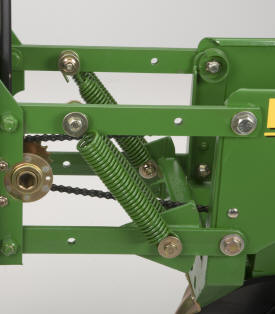 Double non-adjustable downforce springs
Double non-adjustable downforce springs
Downforce springs ensure proper opener blade penetration and assist in maintaining proper seeding depth. In tilled or light soil conditions, only small amounts of downforce are needed. The non-adjustable downforce spring provides approximately 90 lb of downforce to the row unit.
If more downforce is required, a second set of non-adjustable springs may be added by sourcing parts through service parts, increasing the down force to 180 lb per row. Double non-adjustable springs are not compatible with 15-in. row spacing due to interference between adjacent parallel arms.
Vacuum seed meter
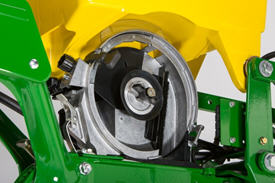 MaxEmerge™ 5 vacuum seed meter
MaxEmerge™ 5 vacuum seed meter

The vacuum meter system gently pulls and holds individual seeds to the holes of the seed disk for population control and spacing accuracy, equaling better crop stands and profit. Vacuum seed meters can plant a wide variety of crops and seed types by simply changing seed disks and adjusting vacuum level. Vacuum seed meters are available for planters with MaxEmerge™ 5 row-units.
Additional features of the vacuum seed meter include:
-
One moving component (the seed metering disk) for minimum maintenance requirements
-
Meter located at each row-unit for accurate seed delivery
-
Good hopper seed flow characteristics for longer operating time per hopper fill
-
Adjustable baffle (MaxEmerge only) to control seed flow into the seed meter reservoir, maintaining proper meter fill for the type of seed being planted
-
Low airflow in meter so seed treatments are not removed
Vacuum meter seed disks
The ProMAX 40 Flat Disk: The flat-disk planting solution field-proven to work since 1991
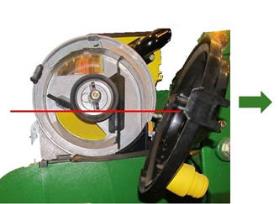 Pro-Series™ seed pool
Pro-Series™ seed pool
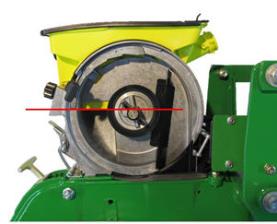 MaxEmerge 5 seed pool
MaxEmerge 5 seed pool
The MaxEmerge 5 Meter shape has also been redesigned for better seed flow. The current production mini-hopper is starved of seed when operating on side hills greater than 9 degrees. The enhancements made to the mini-hopper design with this program allow the planter to successfully operate on side hills up to 14 degrees. This correlates to the planter able to run on a 55 percent greater slope without loss in meter performance.
Vacuum meter hub and latching handle
 MaxEmerge 5 vacuum meter with disk
MaxEmerge 5 vacuum meter with disk

Both the MaxEmerge 5 vacuum meters are equipped with a heavy-duty hub spring and disk latching handle. The spring ensures the seed disk stays properly positioned when operating flat-style seed disks and higher vacuum levels. Proper seed disk positioning means repeatable seed singulation, time after time. The disk latching handle is designed for easy operation and effortless seed disk changeover. The hub is also machined to tight tolerances to further ensure alignment of metering components.
Operating characteristics of vacuum seed meter
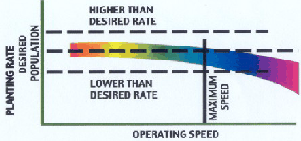 Operating speed with seed tube technology
Operating speed with seed tube technology

The vacuum seed meter is capable of operating at faster planting speeds than mechanical meters (up to 8 mph). However, planting accuracy will be influenced by seedbed conditions and the operating characteristics of the seed meter. Rough seedbeds and fast planting speeds (above 8.9 kmh [5.5 mph]) typically deteriorate seed placement accuracies when using seed tube technology.
The chart illustrates the effect operating speed has on population when using the vacuum meter. The operating band (color area) illustrates how the vacuum meter performs in relation to the desired population (indicated by horizontal line). The width of the band is due to various sizes and shapes of seeds and planting rate variations.
When operating on slopes above 15 degrees, increased or decreased population may result. To minimize this effect, reduce speed and consider using a flat style seed disk with increased vacuum level.
Vacuum blower assembly
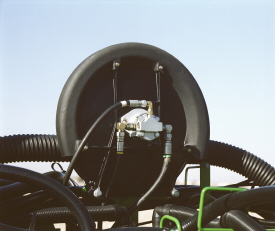 Vacuum blower shown on 1795
Vacuum blower shown on 1795

Vacuum is created by a hydraulically driven vacuum blower assembly mounted on the planter frame. The vacuum blower requires a tractor with a closed-center hydraulic system and a separate selective control valve (SCV). For tractors with open-center hydraulic system, a vacuum 540- or 1000-rpm power take-off (PTO)-driven hydraulic pump system is available. PTO pumps offered from the factory are limited to 15 row applications or less. For applications of 16 rows or more, contact a John Deere dealer.
Vacuum blower assembly capabilities and reliability continue to improve with time. The increased reliability of today's vacuum blowers (since 2006) can be attributed to a larger displacement case drain motor (3.5 cc vs. 2.2 cc) driving a larger diameter blower fan of 47-cm vs. 44-cm (18-5/8 in. vs. 17 3/8-in.) that runs at a slower speed, providing the same amount of vacuum pressure at the seed meter. Another advantage of the larger-diameter fan and larger-displacement case drain pump is that it eliminates the need for a second vacuum blower assembly on a 12-row planter when using a flat seed disk. Current vacuum motors are capable of providing vacuum for 12 row-units running flat disks, or 16 row-units running celled disks.
Different vacuum levels are required depending on the crop to be planted. A hydraulic control valve lets the operator regulate vacuum blower speed, thus changing the vacuum level. On late model John Deere tractors, vacuum levels are set from the tractor seat using the SCV TouchSetTM controls. The control valve is not needed. At full flow, the system flows up to five gpm per motor. Only very large seed or flat seed disks require this much flow.
Convenient vacuum gauges located on the planter hitch give a visual indication of the vacuum level. When using a SeedStar™ monitor, the vacuum level can be displayed on the monitor. Consult the vacuum metering seed charts in the operator's manual for initial vacuum setting recommendations.


John Deere has been making this flat disk since 1991. The ProMAX 40 Flat is designed as a component of the entire John Deere VacuMeter™ system with the intention that the producer will not have to buy a hopper to make it work.
The design of the ProMAX 40 Flat, as well as the positioning of the disk within the meter, allow seed to be released from the optimum position above the seed tube. The Flush-Face seed tube allows seed to drop uninterrupted through the tube, so every seed is properly released into the tube, and every seed clears the tube with even spacing.
The ProMAX 40 Flat does not have cupped cells to help carry the seed, but rather utilizes flat holes and a higher vacuum level to ensure every hole is populated with one or more seeds. A double eliminator gently removes all but one seed at each hole for precise population control. A knockout wheel makes certain that each hole is clear of any debris after the seed is released from the disk.
 Flat-style and cell seed disks shown
Flat-style and cell seed disks shown

Seed disks are made of a durable plastic composition. The unique cell disk design allows planting a variety of seed sizes without any additional parts or individual meter adjustments. Another advantage of cell-type seed disks is the lower vacuum requirement compared to flat-style seed disks. Lower vacuum levels mean less hydraulic demand from the tractor.
Both the MaxEmerge and Pro-Series vacuum seed meters can also utilize flat-style seed disks. These disks are recommended in crops where seed is typically difficult to singulate due to inconsistent seed size or shapes, or on slopes where achieving target populations can be difficult. Flat seed disks do not have a cell to help carry the seed, and thus require higher levels of vacuum to meter seed. Flat-style seed disks do require additional meter components to operate.
Double eliminator
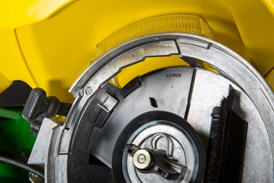

A double eliminator and knockout wheel assembly is needed to singulate seeds when using a flat seed disk. The knockout wheel is installed in place of the wiper used with celled disks.
The MaxEmerge 5 vacuum meter has an external, adjustable double eliminator. This double eliminator uses a knob with numbers to indicate where it should be set for different crops. This feature makes achieving a high level of singulation easier and more consistent.
The adjustment knob is capable of 21 unique positions. The dial is numbered zero through ten in increments of one, but the gearing allows for half increment adjustments as well.
Adjustment time for this double eliminator is estimated to be 10 seconds per row unit, with repeatable results. This means that adjustment can be made three times faster than Pro-Series XP™ units, and eight times faster than MaxEmerge XP units.
Flat and celled type seed metering disks are available to allow planting a wide variety of seed types.
- Corn (field, popcorn or sweet corn)
- Soybeans
- Cotton
- Sorghum
- Sugar beets
- Sunflowers
- Edible beans/peas
- Peanuts
- Melons, squash, cucumbers
Mini-hopper row-units, which are used only with the Central Commodity System (CCS™) are compatible only with crops that the CCS is approved to plant.
- Corn
- Popcorn
- Sweet corn
- Soybeans
- Sunflowers
- Sorghum
- Cotton
NOTE: Due to small seed size and low planting populations, sugar beets can be planted with mini-hopper style meters by adding hopper extensions and not using the CCS tank. These hopper extensions can also be used for planting test plots.
IMPORTANT: Proper seed disk selection is essential for optimum seed meter performance.
Vacuum meter case drain
 Case drain coupler 7000 Series Tractor
Case drain coupler 7000 Series Tractor

All planters with vacuum metering systems have case drain motors on the vacuum blowers. As of May 2004, all case drain lines will have a flush-face case drain coupler on the planter and will require a corresponding flush-face case drain coupler on the tractor. The flush-face coupler simplifies implement attachment by allowing operators to easily identify the case drain. The unique hose tip is unable to hook into another coupler on the tractor, ensuring the correct setup.
It is important to hook up this case drain hose to prevent the continuous and complete draining of hydraulic fluid due to the relief feature that opens the coupler when the pressure reaches 10 psi. This relief feature is designed to protect the motor shaft seal if for any reason the case drain hose was not connected to the tractor. The flush-face hose tips have less back pressure than International Organization for Standardization (ISO) case drain tips, and the flat surface makes these couplers easy to clean, providing less chance for contamination.
The case drain line is also used with all CCS fan motors.
Seed variable-rate drive
Seed variable-rate drive provides the ultimate planting productivity by utilizing one, two, or three hydraulic motors (varies by model) to turn the seeding drive shaft. Hydraulic control of the seeding drive allows for on-the-go seeding rate changes right from the display mounted inside the tractor cab. Combine this seeding flexibility with the map-based planting option, and seeding rates adjust automatically based on the prescribed map.
Variable-rate drive offers the following advantages over common, ground, or contact-tire drive systems:
-
Rate changes are almost instantaneous; no ramp up or ramp down of system as in some competitive systems
- Permits the producer to match seed population based on different soil types or irrigation practices
- John Deere design provides added operator safety by eliminating any possible drive creep found in some competitive variable-rate drive systems
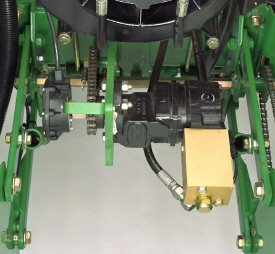 1755 equipped with variable-rate drive
1755 equipped with variable-rate drive
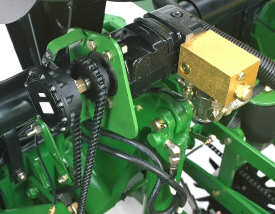 1765NT equipped with variable-rate drive
1765NT equipped with variable-rate drive
Single- or dual-motor systems for variable-rate drives are available for all John Deere planters except the 1785 Rigid Frame. Variable-rate drive is available as a factory-installed option for all applicable planter models.
Single- or dual-motor systems are available as field-installed attachments for most planter models; however, a three-motor variable-rate drive field-installed attachment is not available.
Seed variable-rate drive requires the SeedStar™ monitor and a radar input signal. Either tractor or planter radar may be used. Planter radar is ordered separately.
NOTE: Peanut seed meter disks require the Variable Drive Transmission.
Improved pneumatic downforce system
Pneumatic downforce provides convenient, simple adjustment of downforce for the whole planter from one location. The amount of downforce applied is infinitely adjustable from 0 kg to 181.80 kg (0 lb to 400 lb). Pneumatic downforce provides more consistent downforce throughout the range of row-unit travel than mechanical spring downforce systems.
For model year 2011, several pneumatic downforce system improvements were implemented. Such improvements are:
- 9.5-mm (3/8-in.) air delivery line instead of the 6.4-mm (1/4-in.) line used on model year 2010 and older planters.
- Improved air compressor assembly increased duty cycle. With this new compressor, it provides a 47 percent increase in maximum air flow delivery compared to the prior air compressor.
- New pneumatic air bags with 9.5-mm (3/8-in.) air line inlets that have improved connecting points for greater durability.
Such improvements to the pneumatic downforce system will enable for faster and more precise control of row-unit downforce while planting.
System features
 Pneumatic downforce spring
Pneumatic downforce spring

Each row-unit has a single, rubber air bag located between the parallel arms. The air bags are hooked in parallel so that air can be added or released from all rows at once from one location.
Pneumatic downforce systems are available as base equipment on all 1700 Series and DB planters. The individual pneumatic downforce air bag assemblies, air compressor units, and 9.5-mm (3/8-in.) delivery lines are also available as an attachment for field conversion.
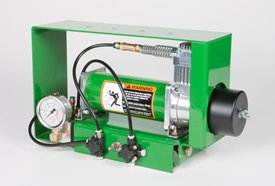 Pneumatic downforce compressor and gauge
Pneumatic downforce compressor and gauge

An improved compressor is used to charge the pneumatic system. This compressor can be located on the planter frame or in the tractor cab if desired. A gauge at the compressor indicates the amount of downforce being applied.
From the factory, integral planter models with pneumatic downforce will have an improved air compressor assembly with an in-cab mounting bracket, except the 1725 16-row and 1725 Central Commodity System (CCS™ ) TR Planters will have the air compressor assembly mounted on the planter frame. For drawn planter models, the 1755, 1765, 1765NT, 1775 Front-Fold, and 1785 Drawn Planters will have the air compressor assembly installed either on the outer hitch or wing frame members when the pneumatic downforce system is installed.
Features
SeedStar™ XP monitoring system
SeedStar XP overview
 SeedStar XP shown on the GreenStar™ 3 2630 Display
SeedStar XP shown on the GreenStar™ 3 2630 Display
 SeedStar XP shown on the GreenStar 2 1800 Display
SeedStar XP shown on the GreenStar 2 1800 Display
Building upon the foundation of SeedStar 2, the SeedStar XP system takes planter monitoring to the next level. SeedStar XP is compatible with the GreenStar 2 1800 and 2600 Displays, GreenStar 3 2630 Display, the Gen 4 4200 CommandCenter™ Display, the Gen 4 4600 CommandCenter Display, the 4240 Universal Display, and the 4640 Universal Display. SeedStar XP is not compatible with the Gen 4 Extended Monitor.
Specific information about how the planter is performing enables the operator to make needed adjustments for implement optimization.
The SeedStar XP planting functions are fully integrated with the full spectrum of Precision Ag Technology applications such as Swath Control Pro™ system for planters, GreenStar AutoTrac™ assisted steering system, John Deere Operations Center, Documentation, and others. Integrated planting technologies for better asset utilization and ease of use is just part of what SeedStar XP provides.
SeedStar XP seed singulation monitoring
 SeedStar XP seed singulation planter run page
SeedStar XP seed singulation planter run page
Understanding the meter singulation performance on the planter is critical to minimizing the amount of seed multiples and skips. As a result, the SeedStar XP monitoring system provides real-time information from the row-units about the overall seed singulation performance.
As seen in the screen shot image above, seed multiple information is displayed on the top portion of the planter-at-a-glance bar with seed skip information on the lower portion. This provides the operator a better understanding of relative seed multiple and skip data on a row-unit basis, all within one easy glance.
Also, within the seed singulation planter run page, information about row-units with the highest percentage of seed multiples and skips is provided in order to make necessary adjustments for better planter optimization.
SeedStar XP row-unit ride dynamics planter run page
 SeedStar XP ride dynamics planter run page
SeedStar XP ride dynamics planter run page
While operating a planter, travel speed and field conditions can affect the amount of row-unit bounce that is experienced. Excessive row-unit bounce or vertical motion can cause problems with meter performance. To better understand the amount of row-unit vertical motion when travelling through a field, the SeedStar XP monitoring system provides real-time information on row-unit ride dynamics.
As seen in the ride dynamics planter-at-a-glance screen shot image above, the SeedStar XP system provides ride dynamic information for each sensor node that is mounted on the planter. Each sensor node transmits ride dynamic information for each planter frame section to allow for the operator to make necessary operating adjustments to improve overall planting performance.
SeedStar XP row-unit downforce planter run page
 SeedStar XP downforce planter run page
SeedStar XP downforce planter run page
As row-unit downforce systems gradually change from heavy-duty downforce springs to pneumatic downforce, being able to understand the amount of as-applied row-unit downforce is needed while operating the planter.
With various soil conditions, moisture, etc. experienced while planting, it is imperative to have the ability to change actual row-unit downforce to have enough force for the Tru-Vee openers to penetrate the soil media. However, in some conditions, having too much downforce applied to the row-units for effective opener penetration could cause problems with side wall compaction from the gauge wheel.
Side wall compaction within the seed furrow can cause hatchet roots to develop, or roots that do not have the ability to penetrate the seed furrow soil media. This could lead to poor plant emergence and eventually lower overall yield performance.
With the SeedStar XP monitoring system, row-unit downforce information is measured by the downforce sensor and sensor nodes and transmitted to the GreenStar 2 Display in the tractor cab (as seen in the image above). The row-unit downforce information is displayed on the top portion of the planter-at-a-glance bar with more row-unit downforce information on the lower portion.
Two different control options are available on 1775NT, 1795, and DB Series Planters for pneumatic downforce. The base pneumatic downforce system requires manual control of the downforce to maintain the desired planting results or row-unit margin. Optional active pneumatic downforce takes SeedStar XP even further by removing constant downforce adjustments from the operator and actively controlling the downforce system to maintain a desired target margin.
SeedStar XP seed spacing monitoring
 SeedStar XP seed spacing planter run page
SeedStar XP seed spacing planter run page
Throughout the planting process, obtaining good seed spacing is critical toward achieving plant growing conditions for maximum yield potential.
Today, many items are adjusted on the planter prior to planting to optimize overall seed spacing performance. After such adjustments are made, information about the actual seed spacing performance during planting was missing within the planter monitoring system. Now with SeedStar XP, seed spacing information is transmitted live via the GreenStar display to show the operator exactly what is happening with the planter behind them.
The SeedStar XP transmits seed spacing information onto the planter-at-a-glance bar for easy understanding of planter seed spacing performance. Also, information about seed skips and multiples is provided to help understand actual planter meter performance and other related system functions in order to make necessary adjustments if needed.
NOTE: Seed spacing and seed singulation information is only available when planting crops with seed drop rates below 40 seeds per second such as corn. With higher population crops such as soybeans the system does not provide spacing and singulation information because the number of seeds dropping per second is much higher.
SeedStar XP full planter performance page
 SeedStar XP planter details
SeedStar XP planter details
With the capability of monitoring differences in planting performance items such as seed singulation and row-unit downforce, having one screen to view all planter performance elements is needed to understand the whole planting system. SeedStar XP combines all of the various planting performance elements into one full-color, planter overview screen to enable for a quick understanding of relative planting functionality.
SeedStar XP half screens and other features
 SeedStar XP seed singulation half screen
SeedStar XP seed singulation half screen
 SeedStar XP seed spacing half screen
SeedStar XP seed spacing half screen
Other SeedStar XP monitoring features include:
- Capable of monitoring individual row-unit and overall planter performance in terms of seed spacing, singulation, and row-unit downforce
- Split-screen applications to enable use of popular guidance features such as AutoTrac assisted steering system
- On-screen indication of sensor node/downforce sensor assemblies once configured within the monitor settings application
- Full-color display icons for easy recognition and overall aesthetics
- Pneumatic downforce system controls with the GS display application
SeedStar 2 monitoring original features
SeedStar XP retains all of those SeedStar 2 features that producers value and have come to expect:
-
Planter-at-a-glance – allows operator to view relative population levels of all rows on one screen.
-
Automatic valve calibration – with the SeedStar variable-rate drive (VRD), this is now completed automatically. There is no longer a need to manually calibrate the hydraulic valves.
-
Increased population updates – SeedStar will now update population levels once per second at planter start up then approximately once every three seconds.
-
Mapping of actual seed rates – when combined with documentation, actual and target seeding rates can now be mapped in John Deere Operations Center.
-
Reprogrammable utilizing controller area network (CAN) via Service ADVISOR™ diagnostics system.
-
Improved diagnostics/event recorder – on SeedStar VRD planters, additional diagnostic information is available, as well as an event recorder to capture system performance data at a specific point in time.
-
Ability to run motors at different population levels – on SeedStar VRD, operators running multiple motor systems can run each motor at a different speed, allowing different population levels within a planter.
-
User-configurable high fertilizer pressure alarm – allows the operator to be warned when fertilizer pressure reaches a specific level.
-
Automatic quick-start for SeedStar VRD – no longer does the operator need to press the quick-start button on end row turns to resume planting.
-
Automatic tractor speed source selection – when equipped with an 8000/9000 Series Tractor, the system selects the radar speed or allows for manual speed input selection.
Components and operation
 Planter main 2 controller
Planter main 2 controller
 Sensor node assembly installed
Sensor node assembly installed
The SeedStar XP monitoring system contains the following components in order to support the planting data transfer to the GreenStar 2 Displays:
- Seed monitor/variable-rate (SMVR) controller with model year 2011 or newer software
- Planter main 2 controller (installed on all SeedStar XP eligible models for model year 2011 or newer)
- Sensor node(s)
- Downforce sensor assembly
The planter main 2 controller processes the row-unit data from the sensor node assemblies located on the row-unit head casting. The processed information is then sent to the SMVR controller to be integrated into the displayed information being sent to the GreenStar Display.
Downforce sensor assemblies are found on row-units with sensor nodes installed. The downforce sensor assembly is assembled with the gauge wheel depth-adjustment handle and provides gauge wheel pressure information to the respective sensor node for data processing.
 Downforce sensor installed
Downforce sensor installed
 Downforce sensor assembly
Downforce sensor assembly
Depending on the planter size, different configurations of sensor nodes and downforce sensors are installed in support of the SeedStar XP monitoring system.
DB fertilizer options
Option code 2625 – Liquid fertilizer with row-unit mounted in-furrow applicator:
- This option contains a ground driven pump, plumbing to a manifold, and routing to each row-unit. The in-furrow applicator places fertilizer after the seed and before the closing wheels.
The DB60 24Row Split 47 Planter and DB60 24Row Split 48 Planter applies fertilizer on 76.2-cm (30-in.) row spacing only.
Drawbar hitch
 Drawbar hitch
Drawbar hitch

A factory-installed, optional drawbar hitch is available for use with 1775NT 16- and 24-Row, 1775NT Central Commodity System (CCS™) 16- and 24-Row, and 12.2-m (40-ft) 1795 Planters. For all DB models the drawbar hitch is in base. All DB models are available with Category 5 drawbar hitch. The following DB models are not available with Category 4 drawbar hitch: DB80 48R20, DB88 48R22, DB90 36R30, DB90 54R20, and DB120 48R30.
The planter drawbar hitch provides easy operation with plenty of ground clearance. The hitch design utilizes a hydraulic cylinder to raise the planter hitch for transport. Hydraulic oil for the hitch cylinder on 1775NT and 1795 Planters comes from the row marker system. Activation of this cylinder is accomplished using a single switch on the display and the marker selective control valve (SCV).
Due to the hydraulic system design, the drawbar hitch requires the planter be equipped with independent markers (not tied to planter lift circuit). Removal of markers from all planters, except the 1775NT 24Row30, makes the drawbar hitch inoperable. The 1775NT 24Row30 is the only planter where the drawbar hitch, less markers, is a valid combination.
For planting on 38.1-cm (15-in.) row spacing with a 16/32-Row 1795 Planter, the drawbar needs to be offset 19-cm (7.5-in.) on the tractor to center the planting rows behind the tractor. When the 16/32 1795 has a drawbar hitch, operators may not be able to offset the hitch to the exact specifications of 19-cm (7.5-in.) when planting in 38.1-cm (15-in.) operation, and could be off as much as a 1.3-cm (0.5-in.). To compensate, additional adjustments to the marker will be necessary.
When using a guidance system such as parallel tracking or AutoTrac™ assisted steering system, operators will need to use their implement offset when planting with all rows on 1795 Planters equipped with the drawbar hitch to compensate for the offset.
The drawbar hitch is ideal for those who have 9000 Series Tractors without a 3-point hitch. For these, the planter drawbar hitch is the economical choice instead of adding a 3-point hitch.
To accept the planter drawbar hitch, the tractor drawbar must be ordered with, or upgraded to, a Category 4 drawbar with the heavy-duty package or Category 5 to be compatible. Track tractors with wide-swinging drawbars are not compatible with the planter drawbar hitch due to a lower hitch-load capacity.
Each 1795 or 1775NT Planter ordered with the drawbar hitch will be shipped with a Category 4 hitch link installed. A Category 5 hitch link is also shipped with the planter if the planter is to be used with a Category 5 drawbar. See pre-delivery instructions included with the planter for changeover information.
Compatibility:
- Category 5 implement hitch links are not compatible with Category 4 tractor drawbars.
- Category 5 tractor drawbars are not compatible with Category 4 implement hitch links.
This hitch also adds 0.6-m (2-ft) to planter length during transport and field operation. There are some combinations of planter options that are not compatible with the drawbar hitch option due to tractor drawbar limitations.
Downforce system options

Heavy-duty adjustable downforce springs
 Heavy-duty adjustable downforce spring
Heavy-duty adjustable downforce spring
Planter row-unit downforce is an important factor to ensure consistent and proper depth control. The heavy-duty adjustable downforce feature provides up to 181.4 kg (400 lb) of downforce. There are four settings available to allow the operator to choose the amount of downforce required for the condition: 0 kg (0 lb), 56.7 kg (125 lb), 113.4 kg (250 lb), and 181.4 kg (400 lb).
Compatibility: 1705, 1715, 1725, 1735, 1755, 1765, 1765NT, 1775 Flex, and 1785
Standard pneumatic downforce system
Pneumatic downforce provides convenient, simple adjustment of downforce for the whole planter from one location. The amount of downforce applied is infinitely adjustable from 0 to 181.4 kg (0 to 400 lb). Pneumatic downforce provides more consistent downforce throughout the range of row-unit travel than mechanical spring downforce systems.
Features include:
- 9.5-mm (3/8-in.) air delivery line instead of the 6.4-mm (1/4-in.) line used on model year 2010 and older planters.
- Air compressor assembly increased duty cycle. With this compressor, it provides a 47 percent increase in maximum air flow delivery compared to the prior air compressor.
- Pneumatic air bags with 9.5-mm (3/8-in.) air line inlets that have greater durability.
 Pneumatic downforce spring
Pneumatic downforce spring
Each row-unit has a single rubber air bag located between the parallel arms. The air bags are hooked in parallel so that air can be added or released from all rows at once from one location.
The individual pneumatic downforce air bag assemblies, air compressor units, and 9.5-mm (3/8-in.) delivery lines are also available as an attachment for field conversion.
 Pneumatic downforce compressor and gauge
Pneumatic downforce compressor and gauge
An improved compressor is used to charge the pneumatic system. This compressor can be located on the planter frame or in the tractor cab if desired. A gauge at the compressor indicates the amount of downforce being applied.
From the factory, integral planter models with pneumatic downforce will have an improved air compressor assembly with an in-cab mounting bracket, except for the 1725 16-row and 1725 Central Commodity System (CCS™) twin-row planters, which will have the air compressor assembly mounted on the planter frame. For drawn planter models, the 1755, 1765, 1765NT, 1775 Front-Fold, and 1785 Drawn Planters will have the air compressor assembly installed either on the outer hitch or wing frame members when the pneumatic downforce system is installed.
Base equipment on: 1705, 1715, 1725, 1735, 1755, 1765, 1765NT, 1775 and 1785.
Integrated pneumatic downforce system
The functional features of the integrated system are the same as the standard pneumatic system, explained above, with the addition of control through the GreenStar™ display.
SeedStar XP row-unit downforce planter run page
 SeedStar XP downforce planter run page
SeedStar XP downforce planter run page
Active downforce control is integrated into SeedStar XP and SeedStar 3 HP monitoring systems.
Margin is the amount of weight riding on the depth gauge wheels that ensures desired firming of the seedbed as set by the operator.
Once a target margin has been defined, enter the value into SeedStar XP or SeedStar 3 HP and let active downforce do the rest. The system will actively adjust the air pressure in the air bags to maintain a constant margin across the planter. The changes in air pressure will change the amount of downforce placed on the row-unit, compensating and reacting for varying conditions through the field whether it is different tillage practices, soil types, or moisture.
System control with the GreenStar display
 Pneumatic downforce control in GreenStar 2 Display
Pneumatic downforce control in GreenStar 2 Display
 Air compressor mounted on 1775NT outer hitch
Air compressor mounted on 1775NT outer hitch
On 1725 16-row, 1725 CCS TR, 1775NT, 1775NT CCS, 1795, DR, and DB Series Planter models, the air compressor will be mounted on the outer hitch or frame assembly. Since the air compressor assembly is mounted on the outer hitch (as noted in the picture above) or frame, adjustments for row-unit downforce and related system pressures will be made electronically with the GreenStar display.
When adjusting the amount of row-unit downforce using the GreenStar display, the operator will select the amount of downforce (kg [lb]) to be applied across the planter. Depending on the soil conditions at hand, the operator might need to adjust the relative amount of row-unit downforce being applied during the planting operation. The integrated pneumatic downforce controls within the GreenStar display will only allow for set-point operation and not automatic control as the planter is operating in different soil conditions. The pneumatic downforce system does not have the capability to automatically adjust downforce.
On-board air storage
 Onboard air storage installed on 1775NT 24R30
Onboard air storage installed on 1775NT 24R30
The 1725 16-row, 1725 CCS TR, 1775NT, 1775NT CCS, 1795, DR, and DB Series planters will have onboard air storage to increase the overall response time when making a row-unit downforce adjustment from the GreenStar display. The onboard air storage is comprised of a 18.9-L (5-gal.) storage tank with valve assembly.
Base equipment on: 1725 CCS, 1725 16-row, 1725T, 1775NT, 1775NT CCS, 1795, DR, and DB Series Planters with MaxEmerge™ 5 row-units. MaxEmerge 5e and ExactEmerge™ equipped planters come with active pneumatic downforce in base.
Active pneumatic downforce
 Active downforce compressor assembly
Active downforce compressor assembly
 Hydraulic motor
Hydraulic motor
A hydraulically driven compressor works with the SeedStar™ 3 HP system and SeedStar XP system to automate downforce control. Just set the row-unit target margin value and the active pneumatic downforce system works automatically. The system will make sure the planter maintains this value, achieving precise soil penetration, and consistent planting depth, without sidewall soil compaction. From the factory, the system is set at 45.4 kg (100 lb) target downforce margin, but may be modified for varying field conditions. This frees the operator from constantly making manual downforce adjustments as conditions change.
This system offers a split-rank control feature for 1795 and DB Split-Row Planters. On split-row planters, active downforce will control the front and rear rows independently. This compensates for differing downforce requirements between the ranks that can be caused by things like different tillage or insecticide attachments and will help maintain an accurate planting depth and consistent margin across all the rows.
Active pneumatic downforce is available as factory installed or as an attachment for field conversion.
 IRHD screen showing the ground contact graph
IRHD screen showing the ground contact graph
 IRHD screen showing the applied downforce graph
IRHD screen showing the applied downforce graph
Optional equipment on: 1775NT, 1795, DB, and Orthman custom models with MaxEmerge 5e and ExactEmerge row-units.
 Downforce and margin example
Downforce and margin example
- A - Margin – amount of additional downforce applied to a row-unit above and beyond what is required for penetration to achieve planting depth. This additional weight will ride on the depth gauge wheels. 54.4 kg (120 lb) + 36.3 kg (80 lb) = 90.7 kg (200 lb) – 68 kg (150 lb) = 22.7 kg (50 lb) of margin
- B - Weight of row-unit - 54.4 kg (120 lb)
- C - Downforce – force that is applied to the row-unit by the air bag circuit - 36.3 kg (80 lb)
- D - Resistance from soil - 68 kg (150 lb)
Hydraulically driven compressor
 Hydraulic motor
Hydraulic motor
 Pneumatic valve
Pneumatic valve
The hydraulically driven air compressor can deliver up to eight times the air flow, allowing for more and faster downforce changes to be made. This more robust design features a 37.8-L (10-gal.) storage tank across all models with active downforce.
At approximately 15.1 L/min (4 gpm), hydraulic demands are low and ties into the machine’s lift and CCS hydraulic circuit so it does not require any additional selective control valves (SCVs). The SeedStar XP and SeedStar 3 HP monitoring systems work with the compressor and valve assembly to regulate air to downforce springs, enabling the active control.
Another feature of John Deere active downforce is the ability for the pneumatic valve to independently control split-rank machines. This system senses the downforce needs from the front and rear ranks separately and independently adjusts air pressures with the dual-rank pneumatic valve when equipped. Active pneumatic downforce requires SeedStar XP or SeedStar 3 HP to enable active control.
Base equipment on: All MaxEmerge 5e and ExactEmerge equipped planter models.
Individual Row Hydraulic Downforce (IRHD)

IRHD has been specifically designed to meet the needs of producers that are looking to adjust to the toughest field conditions and provide maximum yield potential from field to field, season after season. IRHD works as a closed-loop downforce system that reacts quickly on an individual row basis to changing soil conditions supporting increased ground contact, which can lead to improved seed depth consistency. When setting planter downforce margin, the system will apply the needed downforce by row to maintain ground contact. From the factory, the margin will be set at 45.4 kg (100 lb), changes may be required based on varying field conditions.
The system allows operators to maintain gauge wheel ground contact leading to desired seed depth placement. IRHD can adjust five times per second and make adjustments of 45.4 kg (100 lb) in less than a second. The system has a total range of applied downforce from 22.7 kg (50 lb) to 204.1 kg (450 lb) and utilizes the power beyond circuit on the tractor. IRHD is 58 percent faster than the active pneumatic downforce solution. Fast reaction and increased ground contact can lead to improved emergence. With uniform emergence, some studies have shown a yield impact from 5 percent to 9 percent.
IRHD is controlled through the Gen 4 4600 CommandCenter™ Display or 4640 Universal Display with SeedStar 4HP. As shown below, operators can view ground contact or applied downforce using the toggle button.
Row cleaner options to meet residue management needs
Crop yields have increased through the years along with the amount of residue left in the field after harvest. At the same time, tillage practices have changed, including different tillage operations which maintain large amounts of surface residue, and even no-till practices. Row cleaners are an essential tool in managing this increased amount of residue.
John Deere seeding group offers a variety of row cleaner options to meet the needs of a producer's operation. Compatibility varies by model, row spacing, and other planter equipment.
Screw-adjust, unit-mounted row cleaner
 Screw-adjust, unit-mounted row cleaner
Screw-adjust, unit-mounted row cleaner
The screw-adjust, unit-mounted row cleaner is mounted directly to the face plate of the row-unit, placing the ground engaging components just in front of the row-unit opener blades and depth gauge wheels. This close proximity allows the gauge wheels to control the depth of the row cleaner as well as the row-unit. This compact design also allows greater compatibility with fertilizer openers and other planter attachments.
SharkTooth® wheels are standard equipment on the unit-mounted row cleaner. The swept-tooth design of the wheel provides a clear path for the row-unit openers while resisting residue buildup on the wheel. The screw adjustment knob is accessible through the top of the parallel arms, providing convenient access for adjustments. The row cleaner can be adjusted in 1.6-mm (1/16-in.) increments, providing plenty of flexibility to meet the needs of changing conditions.
Floating row cleaner with unit-mounted coulter
 Floating row cleaner with unit-mounted coulter
Floating row cleaner with unit-mounted coulter
The floating row cleaner allows a row cleaner to be used in conjunction with a unit-mounted coulter. This combination is often desired in heavy residue loads and reduced tillage planting conditions. The row cleaner provides a clear path for the row-unit, while the unit-mounted coulter helps penetrate tough soil conditions.
Accommodating the unit-mounted coulter means the residue wheels are farther forward from the row-unit face plate than in the case of the screw-adjust row cleaner. To maintain performance, this row cleaner has the capability to float above a defined minimum depth.
Standard depth-gauging bands on the wheels allow the row cleaner wheels to float independently of the row-unit openers, allowing both to perform in varying terrain. The unit may also be set in a fixed position by simply pinning through the bracket if desired. This row cleaner also features SharkTooth wheels as standard equipment.
The floating row cleaner and unit-mounted coulters are available on many planters as factory-installed equipment. As compatibility and details vary by model, review the following links for information on specific planter models.
NOTE: Screw-adjust row cleaners are not compatible with MaxEmerge™ 5e row-units with long parallel arms.
NOTE: DB models have the option for either unit-mounted coulter, screw-adjust row cleaners, or pneumatic row cleaners (only compatabile with MaxEmerge 5e or equipped ExactEmerge™ models). The DB60T is only available with a less row cleaner option.
SharkTooth is a trademark of Yetter Manufacturing, Inc.
RowCommand™ individual-row control system
RowCommand controls seed output
 RowCommand on a MaxEmerge™ 5 row-unit
RowCommand on a MaxEmerge™ 5 row-unit
 RowCommand on a chain drive MaxEmerge 5 row-unit
RowCommand on a chain drive MaxEmerge 5 row-unit
Controlling input costs and improving productivity are key producer requirements today. RowCommand is an effective, integrated John Deere solution designed to meet these intensifying needs. The RowCommand system manages seed output, reduces yield drag, and improves harvest capabilities on all Pro-Shaft™ driven row-units, and chain-driven MaxEmerge 5.
NOTE: Chain-drive RowCommand is only compatible with planters equipped with pneumatic downforce systems. On planters equipped with the heavy-duty downforce springs, potential chain interference may result and is not recommended.
NOTE: Chain-drive RowCommand requires some modification to brackets in order to function with corn finger pickup meters.
NOTE: Pro-Shaft drive RowCommand is compatible on MaxEmerge 5 row-units with vacuum and corn finger pickup meters. For mini-hopper row-units, RowCommand is compatible on vacuum meters only and is not compatible on corn finger pickup meters. Pro-Series™ XP row-units with corn finger pickup meters are not compatible with RowCommand.
RowCommand controls seed output by incorporating individual, low amperage clutches inside the Pro-Shaft and chain-driven gearboxes. Clutches are completely enclosed within the gearbox housing to protect them from the elements and harsh operating conditions.
When power is supplied, either manually or through John Deere Section Control software, clutches disengage the seed meters and seed flow stops. Controlling seed output at individual rows reduces overplanting in point rows and maximizes seed placement when entering/exiting headlands.
Components and operation
 Electronic power modules shown on a 1775NT Planter
Electronic power modules shown on a 1775NT Planter
 RowCommand clutch on MaxEmerge 5 with 105.7-L (3-bu) hopper
RowCommand clutch on MaxEmerge 5 with 105.7-L (3-bu) hopper
RowCommand is a simple and efficient solution to control individual row planting. This system does not utilize air to operate; therefore, no compressor, air lines, or valve modules are required.
RowCommand utilizes low-voltage controller area network (CAN) messaging to signal power to the desired clutches to stop planting or eliminates power to resume planting.
This means very little power is used in normal planting conditions, and in the event a clutch fails electrically, the meter will continue to plant.
The RowCommand system requires the following five basic components to operate:
-
Electric clutches
-
Electronic power modules (EPMs)
-
SeedStar™ 2 monitoring (wedge box/controller)
-
GreenStar™ (GS) display
-
Planter wiring harnesses
Clutches are protected within the sealed Pro-Shaft and chain-driven gearboxes for years of trouble-free operation and simple installation or removal. RowCommand has true individual-row control of up to 16 clutches or sections for planters larger than 16 rows.
Unique to RowCommand, the 16 available control sections can be configured based on operator preferences. For example, on a 1775NT 24-Row Planter, every two rows can be paired together for a total of 12 control sections, or control the outermost eight rows individually and the remaining inner rows paired together for 16 control sections.
While SeedStar with RowCommand has 16 control sections, a minimum of 152.4-cm (60-in.) wide sections are recommended for optimum Swath Control Pro™ solution capabilities. As with other Swath Control Pro products, an SF2 signal is the minimum level of accuracy recommend for operation.
Integrated Swath Control Pro
Coupling RowCommand with Swath Control Pro provides the ultimate in precision planting and productivity. One company, one integrated solution are what we offer by incorporating Swath Control Pro capabilities within the SeedStar 2 wedge box (controller). Unlike previous systems, no rate controller, additional harnessing, or components are required to achieve automated individual-row control.
SeedStar 2 monitoring, RowCommand, and Swath Control Pro activation from John Deere Precision Ag Technologies are all that is needed when ordering.
Pro-Shaft drive RowCommand planters
RowCommand is available as a factory-installed option or as an attachment for field conversion attachments for the following Pro-Shaft drive planter models (see chart below).
| Planter model | Row configuration |
| 1725 | 12-row narrow, 12-row wide, and 16-row narrow |
| 1725 Central Commodity System (CCS™) | 16-row narrow |
| 1765 | 12-row narrow |
| 1775 | 12-row narrow |
| 1775NT | 12 row, 16 row, and 24-row narrow |
| 1775NT CCS | 12 row, 16 row, and 24-row narrow |
| 1795 | 12/23 row, 12/24 row, 16/31 row, and 16/32 row |
| 1795 | 24 row, 50.8 cm (20 in.) |
| DB 44 | 24 row, 55.9 cm (22 in.) |
| DB 58 | 32 row, 55.9 cm (22 in.) |
| DB 60 | 36 row, 50.8 cm (20 in.) or 47 row, 38.1 cm (15 in.) |
| DB 66 | 36 row, 55.9 cm (22 in.) |
| DB 80 | 32 row, 76.2 cm (30 in.) or 48 row, 50.8 cm (20 in.) |
| DB 88 | 48 row, 55.9 cm (22 in.) |
| DB 90 | 36 row, 76.2 cm (30 in.) |
| DB 120 | 48 row, 76.2 cm (30 in.) |
| DR (Deere/Orthman™ planter) 16R40 | 16 row, 101.6 cm (40 in.) |
| DR (Deere/Orthman) 18R38 | 18 row, 96.5 cm (38 in.) |
Chain-drive RowCommand planters
In terms of planter compatibility, RowCommand for chain drive is designed for the following planter model configurations equipped with pneumatic downforce systems.
| Planter model | Row configuration |
| 1725 | 12-row narrow, 12-row wide, and 16-row narrow |
| 1765 | 12-row narrow |
| 1775 | 12-row narrow |
| 1775NT | 12 row and 16 row |
| 1775NT CCS | 12 row and 16 row |
| DB 44 | 24 row, 55.9 cm (22 in.) |
Chain-drive RowCommand and heavy-duty downforce
 Chain interference with heavy-duty downforce
Chain interference with heavy-duty downforce
As seen in the image, chain interference may result when operating chain-drive RowCommand on planters equipped with short and long parallel arms and heavy-duty downforce springs.
NOTE: Chain-drive RowCommand is only compatible with planters equipped with pneumatic downforce systems. On planters equipped with the heavy-duty downforce springs, potential chain interference may result and is not recommended.
Chain-drive RowCommand with corn finger pickup meters
 Bracket material removal
Bracket material removal
Due to the design characteristics of the chain-drive RowCommand clutch, some modification to the corn finger pickup meter drive bracket is required. As seen in the picture to the left, some material needs to be removed from the front of the meter drive bracket in order for the chain-drive RowCommand clutch to have sufficient space for installation.
NOTE: Chain-drive RowCommand requires some modification to brackets in order to function with corn finger pickup meters.
RowCommand ordering information
To add RowCommand to a model year 2009 and newer planter model listed above is simple. Pro-Shaft drive attachments for field conversion and chain-drive attachments for field conversion are available by planter model to add the appropriate number of clutches, EPMs, brackets, hardware and row-unit harnesses. For complete installation and part detail for the RowCommand conversion, please use the RowCommand compatibility tool per specific planter model.
RowCommand is compatible and available for model year 2003 (serial number 700101) to 2008 (725101) planter models listed above. In addition to the attachment for field conversion attachment, a planter mainframe harness, SeedStar 2 controller (wedge box), and additional CAN harnesses are needed.
System requirements
RowCommand is a simple and efficient means to control individual row planting through the use of low-voltage electric clutches. When activated, each clutch consumes no more than 0.5 amps. By design, power is only supplied to the clutch when a signal is received to stop planting. In a normal planting condition, no power is supplied and the clutch is de-energized.
Power for the RowCommand system is provided from the 9-pin ISO implement connector. All late-model 8X00 and 9X00 Series John Deere Tractors equipped with the 9-pin ISO implement connector are capable of supplying ample power for system operation.
Along with ample system power, a GreenStar display and SeedStar monitoring are required for operation and control interface. The GreenStar display is where system setup, control settings, and manual control functions are performed.
Seed variable-rate drive (VRD) with half- or three-width disconnect
 VRD shown on a 1775NT
VRD shown on a 1775NT
The seed variable-rate drive provides the ultimate planting productivity by utilizing one, two or three hydraulic motors (varies by model) to turn the seeding drive shaft. Hydraulic control of the seeding drive allows for on-the-go seeding rate changes right from the display mounted inside the tractor cab.
Combine this seeding flexibility with the map-based planting option, and seeding rates adjust automatically based on a prescription map.
Single- or dual-motor systems for variable-rate drives are available for all John Deere planters except the 1785 Rigid Frame. Dual- or three-motor drive systems are commonly used on larger (12-row and more) planters and offer the capability of half-width or three-section drive disconnect.
The VRD is available as a factory-installed option for all applicable planter models. Single- or dual-motor systems are available as field-installed attachments for most planter models; however, a three-motor VRD field-installed attachment is not available.
The seed VRD requires the SeedStar™ monitor and a radar input signal. Either tractor or planter radar may be used. Planter radar is ordered separately.
VRD offers the following advantages over common, contact-tire drive systems:
-
Almost instantaneous rate changes – there is no ramp up or ramp down of system as in some competitive systems
- Permits the operator to match seed population based on different soil types or irrigation practices
- John Deere design that provides added operator safety by eliminating any possible drive creep found in some competitive variable rate drive systems
Half-width drive disconnect
The half-width drive disconnect feature is excellent for the producer concerned with controlling seed costs. This feature helps the operator place seed in the desired area and limit the amount of costly overlapped planting.
The half-width drive disconnect allows the operator to turn off half of the planter at a time for planting end rows, point rows, etc. Variable-rate-equipped planters require two drive motors to utilize the half-width disconnect feature.
 Half-width drive disconnect within frame control
Half-width drive disconnect within frame control
With a 1765, 1765NT, and 1775 12-Row Planter, a single switch box is required for planters that are ordered with variable rate drive and half-width disconnect.
For the 1775NT, 1775NT Central Commodity System (CCS™), and 1795 Front-Folding Planters, the half-width drive disconnect switch is contained within the frame control box, conveniently located in the tractor cab. The function easily shuts off the drive for the left or right half of the planter row-unit seed meters.
Three-width drive disconnect
 Three-width drive disconnect control
Three-width drive disconnect control
Three-width drive disconnect is an option on 1725 12-Row Planters and is base equipment on the 1725 16Row30 Planter. This feature is activated by three individual console mounted switches (control box), conveniently located in the tractor cab. The function easily shuts off the planter row-unit seed meters by one-, two-, or three-drive segments independently.
Central Commodity System (CCS™) seed delivery system
 CCS
CCS

CCS seed delivery adds productivity through increased seed capacity, bulk fill capability, and easy, thorough cleanout.
The two tanks have a combined capacity of 2466.7 L (70 bu) on 9.1-m (30-ft) planters and 3523.9 L (100 bu) on 12.2-m (40-ft) and larger planters. CCS tanks are manufactured using a rotomolded, polyethylene design to ensure maximum durability. The translucent tanks allow easily viewing the amount of seed in the tanks. The tanks are separated by 54.6 cm (21.5 in.) for enhanced rear visibility during transport and backing.
The following crops can be planted with CCS: corn, sweet corn, popcorn, cotton, sunflowers, sugar beets, soybeans, and sorghum (milo).
Filling the tanks is convenient due to a central filling location. The staircase and railing provide access to the filling platform between the tanks. If filling the tanks with an auger, minimum recommendations are a 15.2-cm (6-in.) diameter, 4.3-m (14-ft) auger. Each tank has an adjustable bin-level sensor to alert the operator when it is time to fill.
A standard fill light package is available on machines equipped with CCS. This feature includes two lights conveniently mounted on the railings of the machine. The lights are turned on and off with their own switch located at the bottom of the staircase.
If the seed-carrying vehicle requires hydraulic power to run the unloading system, the auxiliary hydraulic coupler option is available. These couplers are located at the bottom of the staircase and can be coupled under pressure. The system has a separate system filter that ensures the planter hydraulic system remains free of contaminates.
Seed delivery process
CCS is about reducing the time spent filling the planter with seed while maximizing the time spent planting. CCS for planters is a form of seed handling and delivery. The row-units perform the final task of seed metering and placement.
The CCS seed delivery process relies on a hydraulically-driven fan to move seed from the CCS tanks to the row-units. This fan is plumbed in to the planter's raise/lower circuit, so only one selective control valve (SCV) is needed for both functions. When the planter is lowered, lift cylinders bottom out and hydraulic flow is diverted to the seed delivery fan. A flow control valve and gauge, located near the tank, allows for the proper tank pressure setting based on seed type.
Air from the fan pressurizes the CCS tanks and delivers seed to the seed hoppers. Airflow enters the seed tanks through a nozzle in the manifold which pressurizes the tank. The air then picks up seed and moves it out the other end of the nozzle into seed delivery hoses. These hoses route the seed toward the hopper. A small amount of seed is traveling in the delivery hoses only when needed.
The hopper fills with seed until the delivery hose (discharge elbow) is covered. Once the opening is restricted, seed flow through the hose stops. Air flowing to the row-unit travels into the hopper and is the source of air for the vacuum system. This provides a much cleaner air source than previous meter designs. As the seed is picked up by the meter and planted, the seed pool shrinks until the end of the delivery hose is uncovered. At that time, the airflow and seed delivery resume and the seed pool in the hopper is replenished.
CCS tank scales for DB Planter models
The CCS tank scales for DB models are a stand-alone system from Digi-Star®. Load cells are installed at the factory and can be ordered for CCS or CCS with Refuge Plus.
There are three load cells, two at the rear of the CCS cradle and one at the front. They weigh both tanks as one; individual tank weights cannot be determined.
The load cells and display are made by Digi-Star. They are not on the controller aread network (CAN) bus system so they are not integrated into SeedStar™ software in any way. The monitor is sold separately through Digi-Star.
CCS seed cleanout
Seed cleanout could not be much easier with a CCS planter. When finished planting, any remaining seed can simply be removed via access doors at the bottom of the CCS tank.
Because seed is only traveling through the CCS delivery hoses when required by the meter, there is not much left to clean.
CCS seed delivery hoses are then purged with air from the CCS fan, and the excess seed is pushed to the individual meters. The vacuum meter door is opened and seed is removed with the supplied catch pan.
Small seed CCS components
 Manifold nozzle and nozzle with cover installed
Manifold nozzle and nozzle with cover installed
 Straight seed inlet installed in mini-hopper
Straight seed inlet installed in mini-hopper
CCS seed delivery system increases planting productivity across the seven approved crops listed above. While highly effective delivering seed from the CCS tanks to the vacuum meters, small or light seeds (sorghum and small cotton) will require two additional components to aid in proper seed delivery.
Manifold nozzle covers (clips) should be installed to ensure seed is adequately picked up into the air stream for delivery to the row-unit. Mini-hopper discharge elbows should also be changed from the standard elbow (holes) to the small seed elbow (slotted openings) when planting sorghum (milo) and small cotton.
Digi-Star is a trademark of Digi-Star LLC.
Provide added versatility and productivity with Central Commodity System (CCS™) Refuge Plus planter configuration

DB44, DB60, DB60T, DB66, DB80, DB88, DB90, and DB120 Planters can be equipped with the Refuge Plus option from the factory.
The third tank on the Refuge Plus system provides increased versatility and productivity to the planting operation by allowing the grower to plant two different varieties simultaneously. The Refuge Plus tank has manifold nozzles, or outlets, to supply seed to eight different row-units.
Refuge Plus is ideal for the grower planting Bt corn or seed corn. Refuge Plus is the solution for refuge management compliance issues associated with Bt corn production. The 881-L (25-bu) capacity of the third tank makes planting the required 20 percent refuge of non-Bt corn easier while maintaining high productivity levels of the central-fill CCS.
For example, Bt corn planted on 80 percent of the field goes into the larger CCS tanks. The required 20 percent refuge, non-Bt corn, goes into the third Refuge Plus tank with the seed hoses routed to the desired rows.
Central fill with CCS is easier for the seed-corn grower as well. The seed-corn grower can plant both male and female seed in the desired pattern simply by placing the male seed in the Refuge Plus tank, the female seed in the CCS tanks, and routing the seed delivery hoses to the desired row units.
NOTE: Only DB44, DB60, DB60T, DB66, DB80, DB88, DB90, and DB120 Planters can be equipped with the Refuge Plus option from the factory. Other CCS equipped models can add Refuge Plus through Parts.
Redirecting seed delivery
 Seed delivery hose connection and yellow plug
Seed delivery hose connection and yellow plug
Redirecting seed delivery from the CCS tanks to the Refuge Plus tank is fast and easy with quick-disconnect couplers. By simply disconnecting the desired CCS delivery hoses from beneath the CCS tank, capping those hoses and reconnecting the delivery lines to the Refuge Plus tank, the seed delivery source is changed.
Due to the additional weight Refuge Plus places on the planter frame, liquid fertilizer tanks are not compatible. Updated liquid insecticide tank codes have been established for Refuge Plus planters.
Steerable axles
For increased maneuverability into narrow driveways and field approaches, the steerable axle is an option on all DB80, DB88, DB90, and DB120 models. The steerable transport axle still utilizes a pivoting rockshaft with dual lifting cylinders and combines a single steering cylinder with dual linkage assemblies. With the linked pivot points close to the centerline of each wheel, it allows a shorter cylinder stroke and smaller turn angles to translate into a tighter implement turn radius. The same 445/50R22.5 wheels are used with the steerable axle option.
The option will require an extra selective control valve (SCV), independent of all other implement functions. The option code will provide a full manually functioning axle assembly with an included in-cab display for calibrating and reading wheel angle position. The steerable axle package can be used for manual road transport functions around intersections and tight field entrances.
If desired, steerable axles can be combined with John Deere Active Implement Guidance (iSteer™ guidance and machine control system) to provide automatic planter guidance for in-field applications. The following additional components must be purchased separately from John Deere for the steerable axle to compliment Active Implement Guidance.
Components:
- iSteer tractor application controller (with activation)
- iSteer tractor harness
- StarFire™ receiver for planter
All required implement harnessing will be included in the option code. This includes the StarFire receiver harness. The receiver mast will also be provided when the option code is selected.
The purchase, installation, and calibration of the iSteer components are the responsibility of the dealership at time of predelivery.
Features
SeedStar™ 4HP monitoring system
SeedStar 4HP is designed to optimize the in-cab monitoring experience exclusively on the Gen 4 4600 CommandCenter™ display or 4640 Universal Display for growers with ExactEmerge™ planters and MaxEmerge™ 5e planters model year 2018 and newer. With SeedStar 4HP, operators will easily see key planter information with customizable run pages, zoom functionality, and simultaneous graph and performance measurements. SeedStar 4HP is included in base on all model year 2018 ExactEmerge and MaxEmerge 5e planters.
Features overview:
- View multiple planters' at-a-glance bar charts simultaneously
- Three default planter run pages show key planter functions in easy-to-view layouts
- Highly configurable run pages allow SeedStar modules to be customizable
- Zoom feature allows quick row-by-row detailed information
- View dual bar graphs to see multiple planter details at one time
- SeedStar application to make adjustments to planter functions
- Simplified setup through the work set-up page
- Custom rates allow up to six different rates across 48 rows
- The SeedStar 4HP monitoring system requires the Gen 4 4600 CommandCenter or 4640 Universal Display. These displays allow the operator to benefit from the updated interface, enhanced processing speeds, and easy setup (learn more here).
SeedStar 3 HP conversion to SeedStar 4HP with mobile row-unit runoff aftermarket for field conversion kits
Growers who are currently running model year 2017 planters, model year 2017 and newer retrofit kits, or model year 2017 and newer custom-built planters with the SeedStar 3 HP monitoring system can upgrade to the SeedStar 4HP monitoring system with mobile row-unit runoff. The attachment part, AA100382, is software only. The Gen 4 display software version will need to be 19-1 or newer and will require planter apps. Follow the mobile runoff ordering and software push guide below for ordering and installation. Retrofitted planters and custom-built planters will also require the John Deere Connect Mobile kit, 0048PC, from the Precision Ag Technology Price Pages and wiring harness AA83662 to enable the mobile row-unit runoff feature. Please reference Parts Advisor and CCMS Solution 105181 for model-specific mounting brackets. SeedStar 4HP requires the Gen 4 4600 CommandCenter™ v2 display or 4640 Universal Display.
Default planter run pages
 Planter summary default run page
Planter summary default run page
 Planter overview default run page
Planter overview default run page
 Planter details default run page
Planter details default run page
Three default run pages show key planter functions in different views to give fast and easy access to important planter information.
Custom run pages
 Customizable run pages
Customizable run pages
There are customizable run pages that allow the operator to build pages that fit their operation with different modules, like the example shown above.
Zoom functionality
 Zoom feature showing a group of rows
Zoom feature showing a group of rows
 Zoom feature showing a single row
Zoom feature showing a single row
The zoom feature allows the operator to touch a section or row of the planter and get detailed information quickly.
Dual bar graphs
 Dual bar graph showing singulation and population simultaneously
Dual bar graph showing singulation and population simultaneously
Dual bar graphs allow operators to view multiple planter details at one time.
SeedStar application page
 SeedStar application run page
SeedStar application run page
In the SeedStar application, many adjustments can be made, including manually activating section control. SeedStar 4HP allows up to 48 individual row sections. There are several setup features such as crop, seed disk, number of rows being planted, population alarms, and limits. Seed rates can be modified, electric power generation (EPG) can be turned on or off, vacuum can be adjusted, and the fill and purge functions can be used from the SeedStar application. Frame control, as well as diagnostics and calibrations, can be accessed at the bottom of the screen.
Settings Manager in SeedStar 4HP
 Settings Manager screens
Settings Manager screens

Reduce set-up time between changing crops or field conditions by recalling saved settings used previously with Settings Manager, included with every SeedStar 4HP system. This feature allows saving and recalling planter and tractor settings for optimum performance in different conditions.
Settings Manager can be used to save all of the adjustment and inputs associated to a particular crop or condition. An example would be to store all population rates, downforce pressure, row cleaner adjustments, and closing wheel settings for planting corn and storing a separate, unique set of adjustments for soybeans. In addition, Settings Manager stores tractor settings such as selective control valve (SCV) flow and detents, infinitely variable transmission (IVT™) settings, eco modes, and more.
Custom rates in SeedStar 4HP
 Variety set-up page
Variety set-up page
 Rate set-up page
Rate set-up page
 Group rate set-up page
Group rate set-up page
Custom rates allow for individual row population control and row-by-row documentation where up to six different rates can be assigned across an up to 48-row planter. This allows growers interested in planting seed corn with ExactEmerge or MaxEmerge 5e the capability to assign specific populations to male and female rows for planting. This feature can also be used to create tram lines or other applications where custom rates by row are needed.
NOTE: Individual rates are tied to varieties, so each individual rate needs a unique variety name.
Compatibility
| SeedStar 4HP compatibility | |
| Planters | All models ordered with ExactEmerge or MaxEmerge 5e row-units NOTE: Retrofit kits are equipped with SeedStar 3HP only, but can be upgraded by purchasing part number AA100382. |
| Displays | Gen 4 4600 CommandCenter equipped with Version 2 Processor or 4640 Universal Display Dual-display mode is compatible with mid model year 2019 planter software. |
| Active Implement Guidance (AIG) | Compatible with SeedStar 4HP on Gen 4 displays with VT mode and required activations and subscriptions |
| AutoTrac™ Implement Guidance | Not compatible |
| AutoTrac Turn Automation | Not compatible |
Additional information
For additional information on feature functionality on the Gen 4 Display, visit the links below:
YouTube is a trademark of Google LLC.
Easy Fold

Easy Fold is a feature of SeedStar™ 4HP for MaxEmerge™ 5e row-units and ExactEmerge™ row-units equipped on 1775NT and 1795 Planters with a 2-point hitch or DB Planters. This integrated solution replaces the frame-folding box like the manual fold option in SeedStar 3 HP, and it has enhanced the process by controlling and automating the selective control valves (SCVs).
The one-operation fold reduces the need for training inexperienced operators by sequencing the process correctly and reduces time spent folding and unfolding. By utilizing implement automation, the hitch will be controlled by the planter during the fold cycle. Lining up the draft tube to the wing hooks is automated through this process, reducing operator tasks. On DB models, Easy Fold simplifies the folding process functions to one SCV. A manual process is available when needed.
A manual fold option is available from the frame control page on the display for non-compatible or non-equipped tractors or planters. The manual control function is accessible from each step of the Easy Fold process, as shown below.
 Manual control option on SeedStar 4HP
Manual control option on SeedStar 4HP
 Start screen for Easy Fold
Start screen for Easy Fold
 Screen with Easy Fold enabled
Screen with Easy Fold enabled
 Screen with Easy Fold in process
Screen with Easy Fold in process
 Easy Fold completed screen
Easy Fold completed screen
| Easy Fold compatibility | |
| Tractors |
|
| Activation | 2-point hitch equipped planters with Easy Fold require Tractor Implement Automation activation available from the StellarSupport™ portal. This activation is tractor PIN specific and non-transferable. Included in base on model year 2018 compatible tractors. See instructions below. |
| Planters | 1775NT and 1795 with 2-point hitch and DB Planters, equipped with ExactEmerge or MaxEmerge 5e row-units |
| Display | Gen 4 4600 CommandCenter™ Display or 4640 Universal Display |
NOTE: Included in base with ExactEmerge equipped compatible planters. Optional equipment on MaxEmerge 5e equipped compatible planters.
Tractor Implement Automation activation instructions
Use these instructions to download the Tractor Implement Automation activation code at no cost.
- Go to https://www.deere.com/en/stellarsupport/ or https://www.deere.ca/en/stellarsupport/
- Click Product Activation.
- Click Product Activation.
- Select Tractor Automation – Manage Product.
- Add or select existing tractor from list.
- Select the Activate button.
- Select Add Manufacturers drop down menu.
- Select Tractor Implement Automation – John Deere.
- Select Continue – Tractor Implement Automation – John Deere selected.
- Accept the Terms and Conditions.
- Select Finish.
- Take note of the code for use display.
- On the Gen 4 4600 CommandCenter Display or 4640 Universal Display select System, Software Manager.
- Select Activations, then Enter Code from John Deere Stellar Support.
- Enter activation code into the display in the tractor.
- Press next after activating Tractor Implement Automation.
- Take note of the activation code and press OK.
- The Tractor Implement Automation activation will appear the Software Manager screen.
NOTE: Prior to the 18.1 software release, the activation will be shown as “Unknown Implement 1” with a baler icon.
YouTube is a trademark of Google LLC.
Mobile row-unit runoff
 Row Runoff diagnostic test
Row Runoff diagnostic test
 The test functions from a mobile device
The test functions from a mobile device
 Determine optimum settings without being in the cab
Determine optimum settings without being in the cab
The first day of planting season can be as productive as the last with mobile row-unit runoff. The mobile row-unit runoff activation on the planter main controller (PMC) allows operators to make adjustments to maximize row-unit performance from a mobile device at the rear of the planter for both preseason and in-season use - all enabled through the PlanterPlus™ app.
Mobile row-unit runoff allows growers to perform test-stand functions from a mobile device connected to the planter.
The row runoff test provides complete diagnostic checks both preseason and in season. With the row-unit runoff test, the operator can make adjustments from the mobile device, including vacuum pressure, to determine the optimum meter and vacuum settings. This app functionality will help avoid making trips to the cab while validating meter performance.
During preseason planter inspections and set up, utilize the meter performance test to validate meter accuracy, similar to a test stand without leaving the farm. Test all systems on the planter, not just the meter, providing confidence that all planter systems are ready to plant. Reports are generated from the test providing information the operator can save and send for future reference.
Before heading to the field, the operator will benefit from knowing the best row-unit and vacuum settings for each variety selected to plant that spring.
Watch this video to see mobile row-unit runoff in action.
Mobile row-unit runoff will work with any model year 2015 or newer ExactEmerge™ or MaxEmerge™ 5e equipped planter. Mobile row-unit runoff can be added with attachment AA93169.
For model year 2018 and newer ExactEmerge planters, mobile row-unit runoff is included in base equipment. For model year 2018 and newer MaxEmerge 5e planters not equipped from the factory, mobile row-unit runoff can be added with attachment AA93169. A mobile row-unit runoff and Easy Fold package can be added with attachment AA97849 (only available with 1775NT and 1795 Planters with a 2-point hitch and model year 2019 and newer DB Planters with Gen 4 based frame folding).
NOTE: Mobile runoff utilizes PlanterPlus app available on select iPad® tablets, iPhone® smartphones, and Android™ devices.
Mobile row-unit runoff and Easy Fold aftermarket for field conversion kits
The below software bundles include the functionality explained above for machines not ordered with the feature from the factory. Compatible machines include all the necessary sensors and harnesses needed to make the feature function. The attachment part is software only. Follow the mobile runoff ordering and software push guide below for ordering and installation.
SeedStar™ 3 HP conversion to SeedStar 4HP with mobile row-unit runoff aftermarket for field conversion kits
Growers who are currently running model year 2017 planters, model year 2017 and newer performance upgrade kits, or model year 2017 and newer custom built-planters with the SeedStar 3 HP monitoring system can upgrade to the SeedStar 4HP monitoring system with mobile row-unit runoff. The attachment part, AA100382, is software only. The Gen 4 display software version will need to be 19-1 or newer and will require planter apps. Follow the mobile runoff ordering and software push guide below for ordering and installation. Performance upgraded planters and custom-built planters will also require the John Deere Connect Mobile kit, 0048PC, from the Precision Ag Technology Price Pages and wiring harness AA83662 to enable the mobile row-unit runoff feature. Please reference Parts Advisor and CCMS Solution 105181 for model-specific mounting brackets. SeedStar 4HP requires the Gen 4 4600 CommandCenter™ v2 display or 4640 Universal Display.
Mobile runoff ordering and software push guide
iPad and iPhone are trademarks of Apple Inc. Android is a trademark of Google LLC.
Downforce system options

Heavy-duty adjustable downforce springs
 Heavy-duty adjustable downforce spring
Heavy-duty adjustable downforce spring
Planter row-unit downforce is an important factor to ensure consistent and proper depth control. The heavy-duty adjustable downforce feature provides up to 181.4 kg (400 lb) of downforce. There are four settings available to allow the operator to choose the amount of downforce required for the condition: 0 kg (0 lb), 56.7 kg (125 lb), 113.4 kg (250 lb), and 181.4 kg (400 lb).
Compatibility: 1705, 1715, 1725, 1735, 1755, 1765, 1765NT, 1775 Flex, and 1785
Standard pneumatic downforce system
Pneumatic downforce provides convenient, simple adjustment of downforce for the whole planter from one location. The amount of downforce applied is infinitely adjustable from 0 to 181.4 kg (0 to 400 lb). Pneumatic downforce provides more consistent downforce throughout the range of row-unit travel than mechanical spring downforce systems.
Features include:
- 9.5-mm (3/8-in.) air delivery line instead of the 6.4-mm (1/4-in.) line used on model year 2010 and older planters.
- Air compressor assembly increased duty cycle. With this compressor, it provides a 47 percent increase in maximum air flow delivery compared to the prior air compressor.
- Pneumatic air bags with 9.5-mm (3/8-in.) air line inlets that have greater durability.
 Pneumatic downforce spring
Pneumatic downforce spring
Each row-unit has a single rubber air bag located between the parallel arms. The air bags are hooked in parallel so that air can be added or released from all rows at once from one location.
The individual pneumatic downforce air bag assemblies, air compressor units, and 9.5-mm (3/8-in.) delivery lines are also available as an attachment for field conversion.
 Pneumatic downforce compressor and gauge
Pneumatic downforce compressor and gauge
An improved compressor is used to charge the pneumatic system. This compressor can be located on the planter frame or in the tractor cab if desired. A gauge at the compressor indicates the amount of downforce being applied.
From the factory, integral planter models with pneumatic downforce will have an improved air compressor assembly with an in-cab mounting bracket, except for the 1725 16-row and 1725 Central Commodity System (CCS™) twin-row planters, which will have the air compressor assembly mounted on the planter frame. For drawn planter models, the 1755, 1765, 1765NT, 1775 Front-Fold, and 1785 Drawn Planters will have the air compressor assembly installed either on the outer hitch or wing frame members when the pneumatic downforce system is installed.
Base equipment on: 1705, 1715, 1725, 1735, 1755, 1765, 1765NT, 1775 and 1785.
Integrated pneumatic downforce system
The functional features of the integrated system are the same as the standard pneumatic system, explained above, with the addition of control through the GreenStar™ display.
System control with the GreenStar display
 Pneumatic downforce control in GreenStar 2 Display
Pneumatic downforce control in GreenStar 2 Display
 Air compressor mounted on 1775NT outer hitch
Air compressor mounted on 1775NT outer hitch
On 1725 16-row, 1725 CCS TR, 1775NT, 1775NT CCS, 1795, DR, and DB Series Planter models, the air compressor will be mounted on the outer hitch or frame assembly. Since the air compressor assembly is mounted on the outer hitch (as noted in the picture above) or frame, adjustments for row-unit downforce and related system pressures will be made electronically with the GreenStar display.
When adjusting the amount of row-unit downforce using the GreenStar display, the operator will select the amount of downforce (kg [lb]) to be applied across the planter. Depending on the soil conditions at hand, the operator might need to adjust the relative amount of row-unit downforce being applied during the planting operation. The integrated pneumatic downforce controls within the GreenStar display will only allow for set-point operation and not automatic control as the planter is operating in different soil conditions. The pneumatic downforce system does not have the capability to automatically adjust downforce.
On-board air storage
 Onboard air storage installed on 1775NT 24R30
Onboard air storage installed on 1775NT 24R30
The 1725 16-row, 1725 CCS TR, 1775NT, 1775NT CCS, 1795, DR, and DB Series planters will have onboard air storage to increase the overall response time when making a row-unit downforce adjustment from the GreenStar display. The onboard air storage is comprised of a 18.9-L (5-gal.) storage tank with valve assembly.
Base equipment on: 1725 CCS, 1725 16-row, 1725T, 1775NT, 1775NT CCS, 1795, DR, and DB Series Planters with MaxEmerge™ 5 row-units. MaxEmerge 5e and ExactEmerge™ equipped planters come with active pneumatic downforce in base.
Active pneumatic downforce
 Active downforce compressor assembly
Active downforce compressor assembly
 Hydraulic motor
Hydraulic motor
A hydraulically driven compressor works with the SeedStar™ 3 HP system and SeedStar XP system to automate downforce control. Just set the row-unit target margin value and the active pneumatic downforce system works automatically. The system will make sure the planter maintains this value, achieving precise soil penetration, and consistent planting depth, without sidewall soil compaction. From the factory, the system is set at 45.4 kg (100 lb) target downforce margin, but may be modified for varying field conditions. This frees the operator from constantly making manual downforce adjustments as conditions change.
This system offers a split-rank control feature for 1795 and DB Split-Row Planters. On split-row planters, active downforce will control the front and rear rows independently. This compensates for differing downforce requirements between the ranks that can be caused by things like different tillage or insecticide attachments and will help maintain an accurate planting depth and consistent margin across all the rows.
Active pneumatic downforce is available as factory installed or as an attachment for field conversion.
SeedStar XP row-unit downforce planter run page
 SeedStar XP downforce planter run page
SeedStar XP downforce planter run page
Active downforce control is integrated into SeedStar XP and SeedStar 3 HP monitoring systems.
Margin is the amount of weight riding on the depth gauge wheels that ensures desired firming of the seedbed as set by the operator.
Once a target margin has been defined, enter the value into SeedStar XP or SeedStar 3 HP and let active downforce do the rest. The system will actively adjust the air pressure in the air bags to maintain a constant margin across the planter. The changes in air pressure will change the amount of downforce placed on the row-unit, compensating and reacting for varying conditions through the field whether it is different tillage practices, soil types, or moisture.
 Downforce and margin example
Downforce and margin example
- A - Margin – amount of additional downforce applied to a row-unit above and beyond what is required for penetration to achieve planting depth. This additional weight will ride on the depth gauge wheels. 54.4 kg (120 lb) + 36.3 kg (80 lb) = 90.7 kg (200 lb) – 68 kg (150 lb) = 22.7 kg (50 lb) of margin
- B - Weight of row-unit - 54.4 kg (120 lb)
- C - Downforce – force that is applied to the row-unit by the air bag circuit - 36.3 kg (80 lb)
- D - Resistance from soil - 68 kg (150 lb)
Hydraulically driven compressor
 Hydraulic motor
Hydraulic motor
 Pneumatic valve
Pneumatic valve
The hydraulically driven air compressor can deliver up to eight times the air flow, allowing for more and faster downforce changes to be made. This more robust design features a 37.8-L (10-gal.) storage tank across all models with active downforce.
At approximately 15.1 L/min (4 gpm), hydraulic demands are low and ties into the machine’s lift and CCS hydraulic circuit so it does not require any additional selective control valves (SCVs). The SeedStar XP and SeedStar 3 HP monitoring systems work with the compressor and valve assembly to regulate air to downforce springs, enabling the active control.
Another feature of John Deere active downforce is the ability for the pneumatic valve to independently control split-rank machines. This system senses the downforce needs from the front and rear ranks separately and independently adjusts air pressures with the dual-rank pneumatic valve when equipped. Active pneumatic downforce requires SeedStar XP or SeedStar 3 HP to enable active control.
Base equipment on: All MaxEmerge 5e and ExactEmerge equipped planter models.
Individual Row Hydraulic Downforce (IRHD)

IRHD has been specifically designed to meet the needs of producers that are looking to adjust to the toughest field conditions and provide maximum yield potential from field to field, season after season. IRHD works as a closed-loop downforce system that reacts quickly on an individual row basis to changing soil conditions supporting increased ground contact, which can lead to improved seed depth consistency. When setting planter downforce margin, the system will apply the needed downforce by row to maintain ground contact. From the factory, the margin will be set at 45.4 kg (100 lb), changes may be required based on varying field conditions.
The system allows operators to maintain gauge wheel ground contact leading to desired seed depth placement. IRHD can adjust five times per second and make adjustments of 45.4 kg (100 lb) in less than a second. The system has a total range of applied downforce from 22.7 kg (50 lb) to 204.1 kg (450 lb) and utilizes the power beyond circuit on the tractor. IRHD is 58 percent faster than the active pneumatic downforce solution. Fast reaction and increased ground contact can lead to improved emergence. With uniform emergence, some studies have shown a yield impact from 5 percent to 9 percent.
IRHD is controlled through the Gen 4 4600 CommandCenter™ Display or 4640 Universal Display with SeedStar 4HP. As shown below, operators can view ground contact or applied downforce using the toggle button.
 IRHD screen showing the ground contact graph
IRHD screen showing the ground contact graph
 IRHD screen showing the applied downforce graph
IRHD screen showing the applied downforce graph
Optional equipment on: 1775NT, 1795, DB, and Orthman custom models with MaxEmerge 5e and ExactEmerge row-units.
Easy Adjust row cleaners
 Coulter combo row cleaner
Coulter combo row cleaner
 Easy Adjust row cleaner
Easy Adjust row cleaner
Easy Adjust row cleaner and coulter combo provides a pneumatic row tillage solution that is controlled from the seat of the tractor.
Every decision to make an adjustment during spring planting reduces the acres planted per day and can increase or decrease profitability. An adjustment that can be overlooked is row cleaners due to planter size, difficulty to make the adjustment, and varying conditions across fields and time.
 GreenStar™ 3 2630 Display view for row cleaners compatible with SeedStar™ 3 HP
GreenStar™ 3 2630 Display view for row cleaners compatible with SeedStar™ 3 HP
 4600 CommandCenter™ Display and 4640 Universal Display view for row cleaners compatible with SeedStar 4HP
4600 CommandCenter™ Display and 4640 Universal Display view for row cleaners compatible with SeedStar 4HP
With the Easy Adjust row cleaners on ExactEmerge™ planters, operators now have a pneumatic solution to make on-the-go adjustments that is controlled directly from the seat of the cab. They can be raised from the cab as needed with the push of a button for wet areas, waterways, or end rows. For growers using SeedStar 3 HP, the row cleaners are completely integrated into the John Deere GreenStar 3 2630 Display as well as the Gen 4 4600 CommandCenter display or 4640 Universal Display. For growers using SeedStar 4HP, a 4600 CommandCenter display or 4640 Universal Display is required.
The Easy Adjust row cleaners have the capability to save three presets for varying ground engagement based on field conditions. The system is controlled in three sections: at each wing as well as the center (frame or wheel) track rows. The pneumatic lines use air from the active pneumatic downforce compressor, requiring no additional compressor to be installed on the planter. The Easy Adjust row cleaners utilize down and up force air bags. The adjustable air pressure setting for each bag allows the operator to set the ride of the row cleaner depending on the field conditions and the desired results. Making these on-the-go adjustments from tractor cab increases productivity and performance during planting.
For Easy Adjust row cleaner performance upgrade kit options, see the ordering guide.
The row cleaner-only option utilizes parallel linkage to provide the floating action growers require in their fields. Parallel linkage allows for the unit to float up and down in the situation of hills or hard objects. The cleaner and coulter combo does not have parallel linkage, however, the row cleaners have floating rings installed to help provide the same benefits.
The row cleaners utilize the field-proven SharkTooth® design. Row cleaners play a major role in maximizing yield toward uniform emergence, reducing row-unit bounce, and maintaining proper depth. The Easy Adjust row cleaners provide growers with quick and stress-free solutions to customizing the planter in variable field conditions. They are available on ExactEmerge and MaxEmerge 5e equipped planters. They are not integrated into the RowCommand™ feature.
SharkTooth is a trademark of Yetter Manufacturing Incorporated.
Pneumatic closing wheels

Pneumatic closing wheels are compatible with MaxEmerge™ 5e and ExactEmerge™ row-units. They are available on the following models from the factory: 1775NT, 1795, and DB60 models. The pneumatic closing wheels give operators the ability to adjust closing wheels in seconds without leaving the cab of the tractor.
Using the GreenStar™ 3 2630 Display, pneumatic closing wheels can be adjusted to 25 different positions. From the factory the system is setup with two sections, the outer wings and center frame. With this system, producers will see up to a 76 percent increase in consistent force applied at the closing wheel. Consistently applying the correct force at the seed trench is one of the key elements of supporting improved emergence. Studies show potential yield impact on corn from even emergence from 5 percent to 9 percent*.
NOTE: Pneumatic closing wheels can be purchased for existing MaxEmerge 5e and ExactEmerge planters as an aftermarket field kit. Both rubber tire and cast-iron closing wheels are compatible.
Access the pneumatic closing wheels attachment for field conversion (AFC) ordering guide to fit a 1725 CCS, 1775NT, 1795, or DB60 Planter.
*Planting Outcome Effects on Corn Yield: Doerge, Tom, Jeschke, Mark and Carter, Paul
Curve compensation

Terraces or waterways are two of many field obstacles that make planting on a curve challenging. When planters utilize drive shafts, they are not able to control each individual row-unit; as a result, planting on a curve presents an issue of maintaining 100 percent population. Since the inside rows are moving slower than the outside rows, the inside rows will be over populating while the outside rows are under populating.
With ExactEmerge™ planters and equipped MaxEmerge™ 5e planters, the curve compensation feature allows each row to receive an individual signal based on the speed at which the row-unit is moving, maintaining the correct population across the width of the planter. Without curve compensation, there could be as much as a 24 percent drop in population accuracy, which is equivalent to 8,600 seeds per acre when planting at 36,000 seeds per acre. Curve compensation measures acceleration within the main planter controller and utilizes speed inputs to ensure each row has the desired population accuracy.
Row cleaner options to meet residue management needs
Crop yields have increased through the years along with the amount of residue left in the field after harvest. At the same time, tillage practices have changed, including different tillage operations which maintain large amounts of surface residue, and even no-till practices. Row cleaners are an essential tool in managing this increased amount of residue.
John Deere seeding group offers a variety of row cleaner options to meet the needs of a producer's operation. Compatibility varies by model, row spacing, and other planter equipment.
Screw-adjust, unit-mounted row cleaner
 Screw-adjust, unit-mounted row cleaner
Screw-adjust, unit-mounted row cleaner
The screw-adjust, unit-mounted row cleaner is mounted directly to the face plate of the row-unit, placing the ground engaging components just in front of the row-unit opener blades and depth gauge wheels. This close proximity allows the gauge wheels to control the depth of the row cleaner as well as the row-unit. This compact design also allows greater compatibility with fertilizer openers and other planter attachments.
SharkTooth® wheels are standard equipment on the unit-mounted row cleaner. The swept-tooth design of the wheel provides a clear path for the row-unit openers while resisting residue buildup on the wheel. The screw adjustment knob is accessible through the top of the parallel arms, providing convenient access for adjustments. The row cleaner can be adjusted in 1.6-mm (1/16-in.) increments, providing plenty of flexibility to meet the needs of changing conditions.
Floating row cleaner with unit-mounted coulter
 Floating row cleaner with unit-mounted coulter
Floating row cleaner with unit-mounted coulter
The floating row cleaner allows a row cleaner to be used in conjunction with a unit-mounted coulter. This combination is often desired in heavy residue loads and reduced tillage planting conditions. The row cleaner provides a clear path for the row-unit, while the unit-mounted coulter helps penetrate tough soil conditions.
Accommodating the unit-mounted coulter means the residue wheels are farther forward from the row-unit face plate than in the case of the screw-adjust row cleaner. To maintain performance, this row cleaner has the capability to float above a defined minimum depth.
Standard depth-gauging bands on the wheels allow the row cleaner wheels to float independently of the row-unit openers, allowing both to perform in varying terrain. The unit may also be set in a fixed position by simply pinning through the bracket if desired. This row cleaner also features SharkTooth wheels as standard equipment.
The floating row cleaner and unit-mounted coulters are available on many planters as factory-installed equipment. As compatibility and details vary by model, review the following links for information on specific planter models.
NOTE: Screw-adjust row cleaners are not compatible with MaxEmerge™ 5e row-units with long parallel arms.
NOTE: DB models have the option for either unit-mounted coulter, screw-adjust row cleaners, or pneumatic row cleaners (only compatabile with MaxEmerge 5e or equipped ExactEmerge™ models). The DB60T is only available with a less row cleaner option.
SharkTooth is a trademark of Yetter Manufacturing, Inc.
Drawbar hitch
 Drawbar hitch
Drawbar hitch

A factory-installed, optional drawbar hitch is available for use with 1775NT 16- and 24-Row, 1775NT Central Commodity System (CCS™) 16- and 24-Row, and 12.2-m (40-ft) 1795 Planters. For all DB models the drawbar hitch is in base. All DB models are available with Category 5 drawbar hitch. The following DB models are not available with Category 4 drawbar hitch: DB80 48R20, DB88 48R22, DB90 36R30, DB90 54R20, and DB120 48R30.
The planter drawbar hitch provides easy operation with plenty of ground clearance. The hitch design utilizes a hydraulic cylinder to raise the planter hitch for transport. Hydraulic oil for the hitch cylinder on 1775NT and 1795 Planters comes from the row marker system. Activation of this cylinder is accomplished using a single switch on the display and the marker selective control valve (SCV).
Due to the hydraulic system design, the drawbar hitch requires the planter be equipped with independent markers (not tied to planter lift circuit). Removal of markers from all planters, except the 1775NT 24Row30, makes the drawbar hitch inoperable. The 1775NT 24Row30 is the only planter where the drawbar hitch, less markers, is a valid combination.
For planting on 38.1-cm (15-in.) row spacing with a 16/32-Row 1795 Planter, the drawbar needs to be offset 19-cm (7.5-in.) on the tractor to center the planting rows behind the tractor. When the 16/32 1795 has a drawbar hitch, operators may not be able to offset the hitch to the exact specifications of 19-cm (7.5-in.) when planting in 38.1-cm (15-in.) operation, and could be off as much as a 1.3-cm (0.5-in.). To compensate, additional adjustments to the marker will be necessary.
When using a guidance system such as parallel tracking or AutoTrac™ assisted steering system, operators will need to use their implement offset when planting with all rows on 1795 Planters equipped with the drawbar hitch to compensate for the offset.
The drawbar hitch is ideal for those who have 9000 Series Tractors without a 3-point hitch. For these, the planter drawbar hitch is the economical choice instead of adding a 3-point hitch.
To accept the planter drawbar hitch, the tractor drawbar must be ordered with, or upgraded to, a Category 4 drawbar with the heavy-duty package or Category 5 to be compatible. Track tractors with wide-swinging drawbars are not compatible with the planter drawbar hitch due to a lower hitch-load capacity.
Each 1795 or 1775NT Planter ordered with the drawbar hitch will be shipped with a Category 4 hitch link installed. A Category 5 hitch link is also shipped with the planter if the planter is to be used with a Category 5 drawbar. See pre-delivery instructions included with the planter for changeover information.
Compatibility:
- Category 5 implement hitch links are not compatible with Category 4 tractor drawbars.
- Category 5 tractor drawbars are not compatible with Category 4 implement hitch links.
This hitch also adds 0.6-m (2-ft) to planter length during transport and field operation. There are some combinations of planter options that are not compatible with the drawbar hitch option due to tractor drawbar limitations.
DB fertilizer options
Option code 2625 – Liquid fertilizer with row-unit mounted in-furrow applicator:
- This option contains a ground driven pump, plumbing to a manifold, and routing to each row-unit. The in-furrow applicator places fertilizer after the seed and before the closing wheels.
The DB60 24Row Split 47 Planter and DB60 24Row Split 48 Planter applies fertilizer on 76.2-cm (30-in.) row spacing only.
Central Commodity System (CCS™) seed delivery system
 CCS
CCS

CCS seed delivery adds productivity through increased seed capacity, bulk fill capability, and easy, thorough cleanout.
The two tanks have a combined capacity of 2466.7 L (70 bu) on 9.1-m (30-ft) planters and 3523.9 L (100 bu) on 12.2-m (40-ft) and larger planters. CCS tanks are manufactured using a rotomolded, polyethylene design to ensure maximum durability. The translucent tanks allow easily viewing the amount of seed in the tanks. The tanks are separated by 54.6 cm (21.5 in.) for enhanced rear visibility during transport and backing.
The following crops can be planted with CCS: corn, sweet corn, popcorn, cotton, sunflowers, sugar beets, soybeans, and sorghum (milo).
Filling the tanks is convenient due to a central filling location. The staircase and railing provide access to the filling platform between the tanks. If filling the tanks with an auger, minimum recommendations are a 15.2-cm (6-in.) diameter, 4.3-m (14-ft) auger. Each tank has an adjustable bin-level sensor to alert the operator when it is time to fill.
A standard fill light package is available on machines equipped with CCS. This feature includes two lights conveniently mounted on the railings of the machine. The lights are turned on and off with their own switch located at the bottom of the staircase.
If the seed-carrying vehicle requires hydraulic power to run the unloading system, the auxiliary hydraulic coupler option is available. These couplers are located at the bottom of the staircase and can be coupled under pressure. The system has a separate system filter that ensures the planter hydraulic system remains free of contaminates.
Seed delivery process
CCS is about reducing the time spent filling the planter with seed while maximizing the time spent planting. CCS for planters is a form of seed handling and delivery. The row-units perform the final task of seed metering and placement.
The CCS seed delivery process relies on a hydraulically-driven fan to move seed from the CCS tanks to the row-units. This fan is plumbed in to the planter's raise/lower circuit, so only one selective control valve (SCV) is needed for both functions. When the planter is lowered, lift cylinders bottom out and hydraulic flow is diverted to the seed delivery fan. A flow control valve and gauge, located near the tank, allows for the proper tank pressure setting based on seed type.
Air from the fan pressurizes the CCS tanks and delivers seed to the seed hoppers. Airflow enters the seed tanks through a nozzle in the manifold which pressurizes the tank. The air then picks up seed and moves it out the other end of the nozzle into seed delivery hoses. These hoses route the seed toward the hopper. A small amount of seed is traveling in the delivery hoses only when needed.
The hopper fills with seed until the delivery hose (discharge elbow) is covered. Once the opening is restricted, seed flow through the hose stops. Air flowing to the row-unit travels into the hopper and is the source of air for the vacuum system. This provides a much cleaner air source than previous meter designs. As the seed is picked up by the meter and planted, the seed pool shrinks until the end of the delivery hose is uncovered. At that time, the airflow and seed delivery resume and the seed pool in the hopper is replenished.
CCS tank scales for DB Planter models
The CCS tank scales for DB models are a stand-alone system from Digi-Star®. Load cells are installed at the factory and can be ordered for CCS or CCS with Refuge Plus.
There are three load cells, two at the rear of the CCS cradle and one at the front. They weigh both tanks as one; individual tank weights cannot be determined.
The load cells and display are made by Digi-Star. They are not on the controller aread network (CAN) bus system so they are not integrated into SeedStar™ software in any way. The monitor is sold separately through Digi-Star.
CCS seed cleanout
Seed cleanout could not be much easier with a CCS planter. When finished planting, any remaining seed can simply be removed via access doors at the bottom of the CCS tank.
Because seed is only traveling through the CCS delivery hoses when required by the meter, there is not much left to clean.
CCS seed delivery hoses are then purged with air from the CCS fan, and the excess seed is pushed to the individual meters. The vacuum meter door is opened and seed is removed with the supplied catch pan.
Small seed CCS components
 Manifold nozzle and nozzle with cover installed
Manifold nozzle and nozzle with cover installed
 Straight seed inlet installed in mini-hopper
Straight seed inlet installed in mini-hopper
CCS seed delivery system increases planting productivity across the seven approved crops listed above. While highly effective delivering seed from the CCS tanks to the vacuum meters, small or light seeds (sorghum and small cotton) will require two additional components to aid in proper seed delivery.
Manifold nozzle covers (clips) should be installed to ensure seed is adequately picked up into the air stream for delivery to the row-unit. Mini-hopper discharge elbows should also be changed from the standard elbow (holes) to the small seed elbow (slotted openings) when planting sorghum (milo) and small cotton.
Digi-Star is a trademark of Digi-Star LLC.
Provide added versatility and productivity with Central Commodity System (CCS™) Refuge Plus planter configuration

DB44, DB60, DB60T, DB66, DB80, DB88, DB90, and DB120 Planters can be equipped with the Refuge Plus option from the factory.
The third tank on the Refuge Plus system provides increased versatility and productivity to the planting operation by allowing the grower to plant two different varieties simultaneously. The Refuge Plus tank has manifold nozzles, or outlets, to supply seed to eight different row-units.
Refuge Plus is ideal for the grower planting Bt corn or seed corn. Refuge Plus is the solution for refuge management compliance issues associated with Bt corn production. The 881-L (25-bu) capacity of the third tank makes planting the required 20 percent refuge of non-Bt corn easier while maintaining high productivity levels of the central-fill CCS.
For example, Bt corn planted on 80 percent of the field goes into the larger CCS tanks. The required 20 percent refuge, non-Bt corn, goes into the third Refuge Plus tank with the seed hoses routed to the desired rows.
Central fill with CCS is easier for the seed-corn grower as well. The seed-corn grower can plant both male and female seed in the desired pattern simply by placing the male seed in the Refuge Plus tank, the female seed in the CCS tanks, and routing the seed delivery hoses to the desired row units.
NOTE: Only DB44, DB60, DB60T, DB66, DB80, DB88, DB90, and DB120 Planters can be equipped with the Refuge Plus option from the factory. Other CCS equipped models can add Refuge Plus through Parts.
Redirecting seed delivery
 Seed delivery hose connection and yellow plug
Seed delivery hose connection and yellow plug
Redirecting seed delivery from the CCS tanks to the Refuge Plus tank is fast and easy with quick-disconnect couplers. By simply disconnecting the desired CCS delivery hoses from beneath the CCS tank, capping those hoses and reconnecting the delivery lines to the Refuge Plus tank, the seed delivery source is changed.
Due to the additional weight Refuge Plus places on the planter frame, liquid fertilizer tanks are not compatible. Updated liquid insecticide tank codes have been established for Refuge Plus planters.
Increase job performance when planting and spraying
 Connect Mobile comparison map lets users compare two quality layers at once for planting and spraying
Connect Mobile comparison map lets users compare two quality layers at once for planting and spraying
Connect Mobile overview
John Deere Connect Mobile is a solution that utilizes an Apple® iPad® tablet in the cab and helps the operator increase job performance during planting and spraying operations. Connect Mobile documents and displays multiple quality layers, helping the operator monitor and more easily detect problems that can occur during planting and spraying. Connect Mobile also has a common user interface that makes it easy to use between different pieces of John Deere equipment.
Planting attributes
Monitor and document key performance indicators in high-definition map layers and dashboard tiles such as:
- Actual population
- Target population
- Singulation
- Seed-spacing CV
- Applied downforce
- Gauge wheel margin
- Ride quality
- Ground speed
- Variety
Spraying attributes
- Actual rate
- Rate deviation
- Ground speed
- Pressure
In base equipment
Planting
Connect Mobile hardware is factory installed on all model year 2015 and newer planters factory installed with ExactEmerge™ row-units and all model year 2017 and newer planters factory installed with MaxEmerge™ 5e row-units, making it easy to get started with Connect Mobile.
Spraying
Connect Mobile hardware is factory installed on all model year 2018 Sprayers with the 4600 CommandCenter™ display. Producers can also retrofit Connect Mobile on older sprayers with a GreenStar™ 3 2630 Display by installing the sprayer field kit.
Learn more about Connect Mobile in the Field and Crop Solutions section within the Precision Ag Technology product line and how it can improve the quality of a planting and spraying job.
iPad and Apple are trademarks of Apple Inc.
Steerable axles
For increased maneuverability into narrow driveways and field approaches, the steerable axle is an option on all DB80, DB88, DB90, and DB120 models. The steerable transport axle still utilizes a pivoting rockshaft with dual lifting cylinders and combines a single steering cylinder with dual linkage assemblies. With the linked pivot points close to the centerline of each wheel, it allows a shorter cylinder stroke and smaller turn angles to translate into a tighter implement turn radius. The same 445/50R22.5 wheels are used with the steerable axle option.
The option will require an extra selective control valve (SCV), independent of all other implement functions. The option code will provide a full manually functioning axle assembly with an included in-cab display for calibrating and reading wheel angle position. The steerable axle package can be used for manual road transport functions around intersections and tight field entrances.
If desired, steerable axles can be combined with John Deere Active Implement Guidance (iSteer™ guidance and machine control system) to provide automatic planter guidance for in-field applications. The following additional components must be purchased separately from John Deere for the steerable axle to compliment Active Implement Guidance.
Components:
- iSteer tractor application controller (with activation)
- iSteer tractor harness
- StarFire™ receiver for planter
All required implement harnessing will be included in the option code. This includes the StarFire receiver harness. The receiver mast will also be provided when the option code is selected.
The purchase, installation, and calibration of the iSteer components are the responsibility of the dealership at time of predelivery.
Features
SeedStar™ 4HP monitoring system
SeedStar 4HP is designed to optimize the in-cab monitoring experience exclusively on the Gen 4 4600 CommandCenter™ display or 4640 Universal Display for growers with ExactEmerge™ planters and MaxEmerge™ 5e planters model year 2018 and newer. With SeedStar 4HP, operators will easily see key planter information with customizable run pages, zoom functionality, and simultaneous graph and performance measurements. SeedStar 4HP is included in base on all model year 2018 ExactEmerge and MaxEmerge 5e planters.
Features overview:
- View multiple planters' at-a-glance bar charts simultaneously
- Three default planter run pages show key planter functions in easy-to-view layouts
- Highly configurable run pages allow SeedStar modules to be customizable
- Zoom feature allows quick row-by-row detailed information
- View dual bar graphs to see multiple planter details at one time
- SeedStar application to make adjustments to planter functions
- Simplified setup through the work set-up page
- Custom rates allow up to six different rates across 48 rows
- The SeedStar 4HP monitoring system requires the Gen 4 4600 CommandCenter or 4640 Universal Display. These displays allow the operator to benefit from the updated interface, enhanced processing speeds, and easy setup (learn more here).
SeedStar 3 HP conversion to SeedStar 4HP with mobile row-unit runoff aftermarket for field conversion kits
Growers who are currently running model year 2017 planters, model year 2017 and newer retrofit kits, or model year 2017 and newer custom-built planters with the SeedStar 3 HP monitoring system can upgrade to the SeedStar 4HP monitoring system with mobile row-unit runoff. The attachment part, AA100382, is software only. The Gen 4 display software version will need to be 19-1 or newer and will require planter apps. Follow the mobile runoff ordering and software push guide below for ordering and installation. Retrofitted planters and custom-built planters will also require the John Deere Connect Mobile kit, 0048PC, from the Precision Ag Technology Price Pages and wiring harness AA83662 to enable the mobile row-unit runoff feature. Please reference Parts Advisor and CCMS Solution 105181 for model-specific mounting brackets. SeedStar 4HP requires the Gen 4 4600 CommandCenter™ v2 display or 4640 Universal Display.
Default planter run pages
 Planter summary default run page
Planter summary default run page
 Planter overview default run page
Planter overview default run page
 Planter details default run page
Planter details default run page
Three default run pages show key planter functions in different views to give fast and easy access to important planter information.
Custom run pages
 Customizable run pages
Customizable run pages
There are customizable run pages that allow the operator to build pages that fit their operation with different modules, like the example shown above.
Zoom functionality
 Zoom feature showing a group of rows
Zoom feature showing a group of rows
 Zoom feature showing a single row
Zoom feature showing a single row
The zoom feature allows the operator to touch a section or row of the planter and get detailed information quickly.
Dual bar graphs
 Dual bar graph showing singulation and population simultaneously
Dual bar graph showing singulation and population simultaneously
Dual bar graphs allow operators to view multiple planter details at one time.
SeedStar application page
 SeedStar application run page
SeedStar application run page
In the SeedStar application, many adjustments can be made, including manually activating section control. SeedStar 4HP allows up to 48 individual row sections. There are several setup features such as crop, seed disk, number of rows being planted, population alarms, and limits. Seed rates can be modified, electric power generation (EPG) can be turned on or off, vacuum can be adjusted, and the fill and purge functions can be used from the SeedStar application. Frame control, as well as diagnostics and calibrations, can be accessed at the bottom of the screen.
Settings Manager in SeedStar 4HP
 Settings Manager screens
Settings Manager screens

Reduce set-up time between changing crops or field conditions by recalling saved settings used previously with Settings Manager, included with every SeedStar 4HP system. This feature allows saving and recalling planter and tractor settings for optimum performance in different conditions.
Settings Manager can be used to save all of the adjustment and inputs associated to a particular crop or condition. An example would be to store all population rates, downforce pressure, row cleaner adjustments, and closing wheel settings for planting corn and storing a separate, unique set of adjustments for soybeans. In addition, Settings Manager stores tractor settings such as selective control valve (SCV) flow and detents, infinitely variable transmission (IVT™) settings, eco modes, and more.
Custom rates in SeedStar 4HP
 Variety set-up page
Variety set-up page
 Rate set-up page
Rate set-up page
 Group rate set-up page
Group rate set-up page
Custom rates allow for individual row population control and row-by-row documentation where up to six different rates can be assigned across an up to 48-row planter. This allows growers interested in planting seed corn with ExactEmerge or MaxEmerge 5e the capability to assign specific populations to male and female rows for planting. This feature can also be used to create tram lines or other applications where custom rates by row are needed.
NOTE: Individual rates are tied to varieties, so each individual rate needs a unique variety name.
Compatibility
| SeedStar 4HP compatibility | |
| Planters | All models ordered with ExactEmerge or MaxEmerge 5e row-units NOTE: Retrofit kits are equipped with SeedStar 3HP only, but can be upgraded by purchasing part number AA100382. |
| Displays | Gen 4 4600 CommandCenter equipped with Version 2 Processor or 4640 Universal Display Dual-display mode is compatible with mid model year 2019 planter software. |
| Active Implement Guidance (AIG) | Compatible with SeedStar 4HP on Gen 4 displays with VT mode and required activations and subscriptions |
| AutoTrac™ Implement Guidance | Not compatible |
| AutoTrac Turn Automation | Not compatible |
Additional information
For additional information on feature functionality on the Gen 4 Display, visit the links below:
YouTube is a trademark of Google LLC.
Easy Fold

Easy Fold is a feature of SeedStar™ 4HP for MaxEmerge™ 5e row-units and ExactEmerge™ row-units equipped on 1775NT and 1795 Planters with a 2-point hitch or DB Planters. This integrated solution replaces the frame-folding box like the manual fold option in SeedStar 3 HP, and it has enhanced the process by controlling and automating the selective control valves (SCVs).
The one-operation fold reduces the need for training inexperienced operators by sequencing the process correctly and reduces time spent folding and unfolding. By utilizing implement automation, the hitch will be controlled by the planter during the fold cycle. Lining up the draft tube to the wing hooks is automated through this process, reducing operator tasks. On DB models, Easy Fold simplifies the folding process functions to one SCV. A manual process is available when needed.
A manual fold option is available from the frame control page on the display for non-compatible or non-equipped tractors or planters. The manual control function is accessible from each step of the Easy Fold process, as shown below.
 Manual control option on SeedStar 4HP
Manual control option on SeedStar 4HP
 Start screen for Easy Fold
Start screen for Easy Fold
 Screen with Easy Fold enabled
Screen with Easy Fold enabled
 Screen with Easy Fold in process
Screen with Easy Fold in process
 Easy Fold completed screen
Easy Fold completed screen
| Easy Fold compatibility | |
| Tractors |
|
| Activation | 2-point hitch equipped planters with Easy Fold require Tractor Implement Automation activation available from the StellarSupport™ portal. This activation is tractor PIN specific and non-transferable. Included in base on model year 2018 compatible tractors. See instructions below. |
| Planters | 1775NT and 1795 with 2-point hitch and DB Planters, equipped with ExactEmerge or MaxEmerge 5e row-units |
| Display | Gen 4 4600 CommandCenter™ Display or 4640 Universal Display |
NOTE: Included in base with ExactEmerge equipped compatible planters. Optional equipment on MaxEmerge 5e equipped compatible planters.
Tractor Implement Automation activation instructions
Use these instructions to download the Tractor Implement Automation activation code at no cost.
- Go to https://www.deere.com/en/stellarsupport/ or https://www.deere.ca/en/stellarsupport/
- Click Product Activation.
- Click Product Activation.
- Select Tractor Automation – Manage Product.
- Add or select existing tractor from list.
- Select the Activate button.
- Select Add Manufacturers drop down menu.
- Select Tractor Implement Automation – John Deere.
- Select Continue – Tractor Implement Automation – John Deere selected.
- Accept the Terms and Conditions.
- Select Finish.
- Take note of the code for use display.
- On the Gen 4 4600 CommandCenter Display or 4640 Universal Display select System, Software Manager.
- Select Activations, then Enter Code from John Deere Stellar Support.
- Enter activation code into the display in the tractor.
- Press next after activating Tractor Implement Automation.
- Take note of the activation code and press OK.
- The Tractor Implement Automation activation will appear the Software Manager screen.
NOTE: Prior to the 18.1 software release, the activation will be shown as “Unknown Implement 1” with a baler icon.
YouTube is a trademark of Google LLC.
Mobile row-unit runoff
 Row Runoff diagnostic test
Row Runoff diagnostic test
 The test functions from a mobile device
The test functions from a mobile device
 Determine optimum settings without being in the cab
Determine optimum settings without being in the cab
The first day of planting season can be as productive as the last with mobile row-unit runoff. The mobile row-unit runoff activation on the planter main controller (PMC) allows operators to make adjustments to maximize row-unit performance from a mobile device at the rear of the planter for both preseason and in-season use - all enabled through the PlanterPlus™ app.
Mobile row-unit runoff allows growers to perform test-stand functions from a mobile device connected to the planter.
The row runoff test provides complete diagnostic checks both preseason and in season. With the row-unit runoff test, the operator can make adjustments from the mobile device, including vacuum pressure, to determine the optimum meter and vacuum settings. This app functionality will help avoid making trips to the cab while validating meter performance.
During preseason planter inspections and set up, utilize the meter performance test to validate meter accuracy, similar to a test stand without leaving the farm. Test all systems on the planter, not just the meter, providing confidence that all planter systems are ready to plant. Reports are generated from the test providing information the operator can save and send for future reference.
Before heading to the field, the operator will benefit from knowing the best row-unit and vacuum settings for each variety selected to plant that spring.
Watch this video to see mobile row-unit runoff in action.
Mobile row-unit runoff will work with any model year 2015 or newer ExactEmerge™ or MaxEmerge™ 5e equipped planter. Mobile row-unit runoff can be added with attachment AA93169.
For model year 2018 and newer ExactEmerge planters, mobile row-unit runoff is included in base equipment. For model year 2018 and newer MaxEmerge 5e planters not equipped from the factory, mobile row-unit runoff can be added with attachment AA93169. A mobile row-unit runoff and Easy Fold package can be added with attachment AA97849 (only available with 1775NT and 1795 Planters with a 2-point hitch and model year 2019 and newer DB Planters with Gen 4 based frame folding).
NOTE: Mobile runoff utilizes PlanterPlus app available on select iPad® tablets, iPhone® smartphones, and Android™ devices.
Mobile row-unit runoff and Easy Fold aftermarket for field conversion kits
The below software bundles include the functionality explained above for machines not ordered with the feature from the factory. Compatible machines include all the necessary sensors and harnesses needed to make the feature function. The attachment part is software only. Follow the mobile runoff ordering and software push guide below for ordering and installation.
SeedStar™ 3 HP conversion to SeedStar 4HP with mobile row-unit runoff aftermarket for field conversion kits
Growers who are currently running model year 2017 planters, model year 2017 and newer performance upgrade kits, or model year 2017 and newer custom built-planters with the SeedStar 3 HP monitoring system can upgrade to the SeedStar 4HP monitoring system with mobile row-unit runoff. The attachment part, AA100382, is software only. The Gen 4 display software version will need to be 19-1 or newer and will require planter apps. Follow the mobile runoff ordering and software push guide below for ordering and installation. Performance upgraded planters and custom-built planters will also require the John Deere Connect Mobile kit, 0048PC, from the Precision Ag Technology Price Pages and wiring harness AA83662 to enable the mobile row-unit runoff feature. Please reference Parts Advisor and CCMS Solution 105181 for model-specific mounting brackets. SeedStar 4HP requires the Gen 4 4600 CommandCenter™ v2 display or 4640 Universal Display.
Mobile runoff ordering and software push guide
iPad and iPhone are trademarks of Apple Inc. Android is a trademark of Google LLC.
Downforce system options

Heavy-duty adjustable downforce springs
 Heavy-duty adjustable downforce spring
Heavy-duty adjustable downforce spring
Planter row-unit downforce is an important factor to ensure consistent and proper depth control. The heavy-duty adjustable downforce feature provides up to 181.4 kg (400 lb) of downforce. There are four settings available to allow the operator to choose the amount of downforce required for the condition: 0 kg (0 lb), 56.7 kg (125 lb), 113.4 kg (250 lb), and 181.4 kg (400 lb).
Compatibility: 1705, 1715, 1725, 1735, 1755, 1765, 1765NT, 1775 Flex, and 1785
Standard pneumatic downforce system
Pneumatic downforce provides convenient, simple adjustment of downforce for the whole planter from one location. The amount of downforce applied is infinitely adjustable from 0 to 181.4 kg (0 to 400 lb). Pneumatic downforce provides more consistent downforce throughout the range of row-unit travel than mechanical spring downforce systems.
Features include:
- 9.5-mm (3/8-in.) air delivery line instead of the 6.4-mm (1/4-in.) line used on model year 2010 and older planters.
- Air compressor assembly increased duty cycle. With this compressor, it provides a 47 percent increase in maximum air flow delivery compared to the prior air compressor.
- Pneumatic air bags with 9.5-mm (3/8-in.) air line inlets that have greater durability.
 Pneumatic downforce spring
Pneumatic downforce spring
Each row-unit has a single rubber air bag located between the parallel arms. The air bags are hooked in parallel so that air can be added or released from all rows at once from one location.
The individual pneumatic downforce air bag assemblies, air compressor units, and 9.5-mm (3/8-in.) delivery lines are also available as an attachment for field conversion.
 Pneumatic downforce compressor and gauge
Pneumatic downforce compressor and gauge
An improved compressor is used to charge the pneumatic system. This compressor can be located on the planter frame or in the tractor cab if desired. A gauge at the compressor indicates the amount of downforce being applied.
From the factory, integral planter models with pneumatic downforce will have an improved air compressor assembly with an in-cab mounting bracket, except for the 1725 16-row and 1725 Central Commodity System (CCS™) twin-row planters, which will have the air compressor assembly mounted on the planter frame. For drawn planter models, the 1755, 1765, 1765NT, 1775 Front-Fold, and 1785 Drawn Planters will have the air compressor assembly installed either on the outer hitch or wing frame members when the pneumatic downforce system is installed.
Base equipment on: 1705, 1715, 1725, 1735, 1755, 1765, 1765NT, 1775 and 1785.
Integrated pneumatic downforce system
The functional features of the integrated system are the same as the standard pneumatic system, explained above, with the addition of control through the GreenStar™ display.
System control with the GreenStar display
 Pneumatic downforce control in GreenStar 2 Display
Pneumatic downforce control in GreenStar 2 Display
 Air compressor mounted on 1775NT outer hitch
Air compressor mounted on 1775NT outer hitch
On 1725 16-row, 1725 CCS TR, 1775NT, 1775NT CCS, 1795, DR, and DB Series Planter models, the air compressor will be mounted on the outer hitch or frame assembly. Since the air compressor assembly is mounted on the outer hitch (as noted in the picture above) or frame, adjustments for row-unit downforce and related system pressures will be made electronically with the GreenStar display.
When adjusting the amount of row-unit downforce using the GreenStar display, the operator will select the amount of downforce (kg [lb]) to be applied across the planter. Depending on the soil conditions at hand, the operator might need to adjust the relative amount of row-unit downforce being applied during the planting operation. The integrated pneumatic downforce controls within the GreenStar display will only allow for set-point operation and not automatic control as the planter is operating in different soil conditions. The pneumatic downforce system does not have the capability to automatically adjust downforce.
On-board air storage
 Onboard air storage installed on 1775NT 24R30
Onboard air storage installed on 1775NT 24R30
The 1725 16-row, 1725 CCS TR, 1775NT, 1775NT CCS, 1795, DR, and DB Series planters will have onboard air storage to increase the overall response time when making a row-unit downforce adjustment from the GreenStar display. The onboard air storage is comprised of a 18.9-L (5-gal.) storage tank with valve assembly.
Base equipment on: 1725 CCS, 1725 16-row, 1725T, 1775NT, 1775NT CCS, 1795, DR, and DB Series Planters with MaxEmerge™ 5 row-units. MaxEmerge 5e and ExactEmerge™ equipped planters come with active pneumatic downforce in base.
Active pneumatic downforce
 Active downforce compressor assembly
Active downforce compressor assembly
 Hydraulic motor
Hydraulic motor
A hydraulically driven compressor works with the SeedStar™ 3 HP system and SeedStar XP system to automate downforce control. Just set the row-unit target margin value and the active pneumatic downforce system works automatically. The system will make sure the planter maintains this value, achieving precise soil penetration, and consistent planting depth, without sidewall soil compaction. From the factory, the system is set at 45.4 kg (100 lb) target downforce margin, but may be modified for varying field conditions. This frees the operator from constantly making manual downforce adjustments as conditions change.
This system offers a split-rank control feature for 1795 and DB Split-Row Planters. On split-row planters, active downforce will control the front and rear rows independently. This compensates for differing downforce requirements between the ranks that can be caused by things like different tillage or insecticide attachments and will help maintain an accurate planting depth and consistent margin across all the rows.
Active pneumatic downforce is available as factory installed or as an attachment for field conversion.
SeedStar XP row-unit downforce planter run page
 SeedStar XP downforce planter run page
SeedStar XP downforce planter run page
Active downforce control is integrated into SeedStar XP and SeedStar 3 HP monitoring systems.
Margin is the amount of weight riding on the depth gauge wheels that ensures desired firming of the seedbed as set by the operator.
Once a target margin has been defined, enter the value into SeedStar XP or SeedStar 3 HP and let active downforce do the rest. The system will actively adjust the air pressure in the air bags to maintain a constant margin across the planter. The changes in air pressure will change the amount of downforce placed on the row-unit, compensating and reacting for varying conditions through the field whether it is different tillage practices, soil types, or moisture.
 Downforce and margin example
Downforce and margin example
- A - Margin – amount of additional downforce applied to a row-unit above and beyond what is required for penetration to achieve planting depth. This additional weight will ride on the depth gauge wheels. 54.4 kg (120 lb) + 36.3 kg (80 lb) = 90.7 kg (200 lb) – 68 kg (150 lb) = 22.7 kg (50 lb) of margin
- B - Weight of row-unit - 54.4 kg (120 lb)
- C - Downforce – force that is applied to the row-unit by the air bag circuit - 36.3 kg (80 lb)
- D - Resistance from soil - 68 kg (150 lb)
Hydraulically driven compressor
 Hydraulic motor
Hydraulic motor
 Pneumatic valve
Pneumatic valve
The hydraulically driven air compressor can deliver up to eight times the air flow, allowing for more and faster downforce changes to be made. This more robust design features a 37.8-L (10-gal.) storage tank across all models with active downforce.
At approximately 15.1 L/min (4 gpm), hydraulic demands are low and ties into the machine’s lift and CCS hydraulic circuit so it does not require any additional selective control valves (SCVs). The SeedStar XP and SeedStar 3 HP monitoring systems work with the compressor and valve assembly to regulate air to downforce springs, enabling the active control.
Another feature of John Deere active downforce is the ability for the pneumatic valve to independently control split-rank machines. This system senses the downforce needs from the front and rear ranks separately and independently adjusts air pressures with the dual-rank pneumatic valve when equipped. Active pneumatic downforce requires SeedStar XP or SeedStar 3 HP to enable active control.
Base equipment on: All MaxEmerge 5e and ExactEmerge equipped planter models.
Individual Row Hydraulic Downforce (IRHD)

IRHD has been specifically designed to meet the needs of producers that are looking to adjust to the toughest field conditions and provide maximum yield potential from field to field, season after season. IRHD works as a closed-loop downforce system that reacts quickly on an individual row basis to changing soil conditions supporting increased ground contact, which can lead to improved seed depth consistency. When setting planter downforce margin, the system will apply the needed downforce by row to maintain ground contact. From the factory, the margin will be set at 45.4 kg (100 lb), changes may be required based on varying field conditions.
The system allows operators to maintain gauge wheel ground contact leading to desired seed depth placement. IRHD can adjust five times per second and make adjustments of 45.4 kg (100 lb) in less than a second. The system has a total range of applied downforce from 22.7 kg (50 lb) to 204.1 kg (450 lb) and utilizes the power beyond circuit on the tractor. IRHD is 58 percent faster than the active pneumatic downforce solution. Fast reaction and increased ground contact can lead to improved emergence. With uniform emergence, some studies have shown a yield impact from 5 percent to 9 percent.
IRHD is controlled through the Gen 4 4600 CommandCenter™ Display or 4640 Universal Display with SeedStar 4HP. As shown below, operators can view ground contact or applied downforce using the toggle button.
 IRHD screen showing the ground contact graph
IRHD screen showing the ground contact graph
 IRHD screen showing the applied downforce graph
IRHD screen showing the applied downforce graph
Optional equipment on: 1775NT, 1795, DB, and Orthman custom models with MaxEmerge 5e and ExactEmerge row-units.
Easy Adjust row cleaners
 Coulter combo row cleaner
Coulter combo row cleaner
 Easy Adjust row cleaner
Easy Adjust row cleaner
Easy Adjust row cleaner and coulter combo provides a pneumatic row tillage solution that is controlled from the seat of the tractor.
Every decision to make an adjustment during spring planting reduces the acres planted per day and can increase or decrease profitability. An adjustment that can be overlooked is row cleaners due to planter size, difficulty to make the adjustment, and varying conditions across fields and time.
 GreenStar™ 3 2630 Display view for row cleaners compatible with SeedStar™ 3 HP
GreenStar™ 3 2630 Display view for row cleaners compatible with SeedStar™ 3 HP
 4600 CommandCenter™ Display and 4640 Universal Display view for row cleaners compatible with SeedStar 4HP
4600 CommandCenter™ Display and 4640 Universal Display view for row cleaners compatible with SeedStar 4HP
With the Easy Adjust row cleaners on ExactEmerge™ planters, operators now have a pneumatic solution to make on-the-go adjustments that is controlled directly from the seat of the cab. They can be raised from the cab as needed with the push of a button for wet areas, waterways, or end rows. For growers using SeedStar 3 HP, the row cleaners are completely integrated into the John Deere GreenStar 3 2630 Display as well as the Gen 4 4600 CommandCenter display or 4640 Universal Display. For growers using SeedStar 4HP, a 4600 CommandCenter display or 4640 Universal Display is required.
The Easy Adjust row cleaners have the capability to save three presets for varying ground engagement based on field conditions. The system is controlled in three sections: at each wing as well as the center (frame or wheel) track rows. The pneumatic lines use air from the active pneumatic downforce compressor, requiring no additional compressor to be installed on the planter. The Easy Adjust row cleaners utilize down and up force air bags. The adjustable air pressure setting for each bag allows the operator to set the ride of the row cleaner depending on the field conditions and the desired results. Making these on-the-go adjustments from tractor cab increases productivity and performance during planting.
For Easy Adjust row cleaner performance upgrade kit options, see the ordering guide.
The row cleaner-only option utilizes parallel linkage to provide the floating action growers require in their fields. Parallel linkage allows for the unit to float up and down in the situation of hills or hard objects. The cleaner and coulter combo does not have parallel linkage, however, the row cleaners have floating rings installed to help provide the same benefits.
The row cleaners utilize the field-proven SharkTooth® design. Row cleaners play a major role in maximizing yield toward uniform emergence, reducing row-unit bounce, and maintaining proper depth. The Easy Adjust row cleaners provide growers with quick and stress-free solutions to customizing the planter in variable field conditions. They are available on ExactEmerge and MaxEmerge 5e equipped planters. They are not integrated into the RowCommand™ feature.
SharkTooth is a trademark of Yetter Manufacturing Incorporated.
Pneumatic closing wheels

Pneumatic closing wheels are compatible with MaxEmerge™ 5e and ExactEmerge™ row-units. They are available on the following models from the factory: 1775NT, 1795, and DB60 models. The pneumatic closing wheels give operators the ability to adjust closing wheels in seconds without leaving the cab of the tractor.
Using the GreenStar™ 3 2630 Display, pneumatic closing wheels can be adjusted to 25 different positions. From the factory the system is setup with two sections, the outer wings and center frame. With this system, producers will see up to a 76 percent increase in consistent force applied at the closing wheel. Consistently applying the correct force at the seed trench is one of the key elements of supporting improved emergence. Studies show potential yield impact on corn from even emergence from 5 percent to 9 percent*.
NOTE: Pneumatic closing wheels can be purchased for existing MaxEmerge 5e and ExactEmerge planters as an aftermarket field kit. Both rubber tire and cast-iron closing wheels are compatible.
Access the pneumatic closing wheels attachment for field conversion (AFC) ordering guide to fit a 1725 CCS, 1775NT, 1795, or DB60 Planter.
*Planting Outcome Effects on Corn Yield: Doerge, Tom, Jeschke, Mark and Carter, Paul
Curve compensation

Terraces or waterways are two of many field obstacles that make planting on a curve challenging. When planters utilize drive shafts, they are not able to control each individual row-unit; as a result, planting on a curve presents an issue of maintaining 100 percent population. Since the inside rows are moving slower than the outside rows, the inside rows will be over populating while the outside rows are under populating.
With ExactEmerge™ planters and equipped MaxEmerge™ 5e planters, the curve compensation feature allows each row to receive an individual signal based on the speed at which the row-unit is moving, maintaining the correct population across the width of the planter. Without curve compensation, there could be as much as a 24 percent drop in population accuracy, which is equivalent to 8,600 seeds per acre when planting at 36,000 seeds per acre. Curve compensation measures acceleration within the main planter controller and utilizes speed inputs to ensure each row has the desired population accuracy.
Row cleaner options to meet residue management needs
Crop yields have increased through the years along with the amount of residue left in the field after harvest. At the same time, tillage practices have changed, including different tillage operations which maintain large amounts of surface residue, and even no-till practices. Row cleaners are an essential tool in managing this increased amount of residue.
John Deere seeding group offers a variety of row cleaner options to meet the needs of a producer's operation. Compatibility varies by model, row spacing, and other planter equipment.
Screw-adjust, unit-mounted row cleaner
 Screw-adjust, unit-mounted row cleaner
Screw-adjust, unit-mounted row cleaner
The screw-adjust, unit-mounted row cleaner is mounted directly to the face plate of the row-unit, placing the ground engaging components just in front of the row-unit opener blades and depth gauge wheels. This close proximity allows the gauge wheels to control the depth of the row cleaner as well as the row-unit. This compact design also allows greater compatibility with fertilizer openers and other planter attachments.
SharkTooth® wheels are standard equipment on the unit-mounted row cleaner. The swept-tooth design of the wheel provides a clear path for the row-unit openers while resisting residue buildup on the wheel. The screw adjustment knob is accessible through the top of the parallel arms, providing convenient access for adjustments. The row cleaner can be adjusted in 1.6-mm (1/16-in.) increments, providing plenty of flexibility to meet the needs of changing conditions.
Floating row cleaner with unit-mounted coulter
 Floating row cleaner with unit-mounted coulter
Floating row cleaner with unit-mounted coulter
The floating row cleaner allows a row cleaner to be used in conjunction with a unit-mounted coulter. This combination is often desired in heavy residue loads and reduced tillage planting conditions. The row cleaner provides a clear path for the row-unit, while the unit-mounted coulter helps penetrate tough soil conditions.
Accommodating the unit-mounted coulter means the residue wheels are farther forward from the row-unit face plate than in the case of the screw-adjust row cleaner. To maintain performance, this row cleaner has the capability to float above a defined minimum depth.
Standard depth-gauging bands on the wheels allow the row cleaner wheels to float independently of the row-unit openers, allowing both to perform in varying terrain. The unit may also be set in a fixed position by simply pinning through the bracket if desired. This row cleaner also features SharkTooth wheels as standard equipment.
The floating row cleaner and unit-mounted coulters are available on many planters as factory-installed equipment. As compatibility and details vary by model, review the following links for information on specific planter models.
NOTE: Screw-adjust row cleaners are not compatible with MaxEmerge™ 5e row-units with long parallel arms.
NOTE: DB models have the option for either unit-mounted coulter, screw-adjust row cleaners, or pneumatic row cleaners (only compatabile with MaxEmerge 5e or equipped ExactEmerge™ models). The DB60T is only available with a less row cleaner option.
SharkTooth is a trademark of Yetter Manufacturing, Inc.
RowCommand™ individual-row control system
RowCommand controls seed output
 RowCommand on a MaxEmerge™ 5 row-unit
RowCommand on a MaxEmerge™ 5 row-unit
 RowCommand on a chain drive MaxEmerge 5 row-unit
RowCommand on a chain drive MaxEmerge 5 row-unit
Controlling input costs and improving productivity are key producer requirements today. RowCommand is an effective, integrated John Deere solution designed to meet these intensifying needs. The RowCommand system manages seed output, reduces yield drag, and improves harvest capabilities on all Pro-Shaft™ driven row-units, and chain-driven MaxEmerge 5.
NOTE: Chain-drive RowCommand is only compatible with planters equipped with pneumatic downforce systems. On planters equipped with the heavy-duty downforce springs, potential chain interference may result and is not recommended.
NOTE: Chain-drive RowCommand requires some modification to brackets in order to function with corn finger pickup meters.
NOTE: Pro-Shaft drive RowCommand is compatible on MaxEmerge 5 row-units with vacuum and corn finger pickup meters. For mini-hopper row-units, RowCommand is compatible on vacuum meters only and is not compatible on corn finger pickup meters. Pro-Series™ XP row-units with corn finger pickup meters are not compatible with RowCommand.
RowCommand controls seed output by incorporating individual, low amperage clutches inside the Pro-Shaft and chain-driven gearboxes. Clutches are completely enclosed within the gearbox housing to protect them from the elements and harsh operating conditions.
When power is supplied, either manually or through John Deere Section Control software, clutches disengage the seed meters and seed flow stops. Controlling seed output at individual rows reduces overplanting in point rows and maximizes seed placement when entering/exiting headlands.
Components and operation
 Electronic power modules shown on a 1775NT Planter
Electronic power modules shown on a 1775NT Planter
 RowCommand clutch on MaxEmerge 5 with 105.7-L (3-bu) hopper
RowCommand clutch on MaxEmerge 5 with 105.7-L (3-bu) hopper
RowCommand is a simple and efficient solution to control individual row planting. This system does not utilize air to operate; therefore, no compressor, air lines, or valve modules are required.
RowCommand utilizes low-voltage controller area network (CAN) messaging to signal power to the desired clutches to stop planting or eliminates power to resume planting.
This means very little power is used in normal planting conditions, and in the event a clutch fails electrically, the meter will continue to plant.
The RowCommand system requires the following five basic components to operate:
-
Electric clutches
-
Electronic power modules (EPMs)
-
SeedStar™ 2 monitoring (wedge box/controller)
-
GreenStar™ (GS) display
-
Planter wiring harnesses
Clutches are protected within the sealed Pro-Shaft and chain-driven gearboxes for years of trouble-free operation and simple installation or removal. RowCommand has true individual-row control of up to 16 clutches or sections for planters larger than 16 rows.
Unique to RowCommand, the 16 available control sections can be configured based on operator preferences. For example, on a 1775NT 24-Row Planter, every two rows can be paired together for a total of 12 control sections, or control the outermost eight rows individually and the remaining inner rows paired together for 16 control sections.
While SeedStar with RowCommand has 16 control sections, a minimum of 152.4-cm (60-in.) wide sections are recommended for optimum Swath Control Pro™ solution capabilities. As with other Swath Control Pro products, an SF2 signal is the minimum level of accuracy recommend for operation.
Pro-Shaft drive RowCommand planters
RowCommand is available as a factory-installed option or as an attachment for field conversion attachments for the following Pro-Shaft drive planter models (see chart below).
| Planter model | Row configuration |
| 1725 | 12-row narrow, 12-row wide, and 16-row narrow |
| 1725 Central Commodity System (CCS™) | 16-row narrow |
| 1765 | 12-row narrow |
| 1775 | 12-row narrow |
| 1775NT | 12 row, 16 row, and 24-row narrow |
| 1775NT CCS | 12 row, 16 row, and 24-row narrow |
| 1795 | 12/23 row, 12/24 row, 16/31 row, and 16/32 row |
| 1795 | 24 row, 50.8 cm (20 in.) |
| DB 44 | 24 row, 55.9 cm (22 in.) |
| DB 58 | 32 row, 55.9 cm (22 in.) |
| DB 60 | 36 row, 50.8 cm (20 in.) or 47 row, 38.1 cm (15 in.) |
| DB 66 | 36 row, 55.9 cm (22 in.) |
| DB 80 | 32 row, 76.2 cm (30 in.) or 48 row, 50.8 cm (20 in.) |
| DB 88 | 48 row, 55.9 cm (22 in.) |
| DB 90 | 36 row, 76.2 cm (30 in.) |
| DB 120 | 48 row, 76.2 cm (30 in.) |
| DR (Deere/Orthman™ planter) 16R40 | 16 row, 101.6 cm (40 in.) |
| DR (Deere/Orthman) 18R38 | 18 row, 96.5 cm (38 in.) |
Chain-drive RowCommand planters
In terms of planter compatibility, RowCommand for chain drive is designed for the following planter model configurations equipped with pneumatic downforce systems.
| Planter model | Row configuration |
| 1725 | 12-row narrow, 12-row wide, and 16-row narrow |
| 1765 | 12-row narrow |
| 1775 | 12-row narrow |
| 1775NT | 12 row and 16 row |
| 1775NT CCS | 12 row and 16 row |
| DB 44 | 24 row, 55.9 cm (22 in.) |
Chain-drive RowCommand and heavy-duty downforce
 Chain interference with heavy-duty downforce
Chain interference with heavy-duty downforce
As seen in the image, chain interference may result when operating chain-drive RowCommand on planters equipped with short and long parallel arms and heavy-duty downforce springs.
NOTE: Chain-drive RowCommand is only compatible with planters equipped with pneumatic downforce systems. On planters equipped with the heavy-duty downforce springs, potential chain interference may result and is not recommended.
Chain-drive RowCommand with corn finger pickup meters
 Bracket material removal
Bracket material removal
Due to the design characteristics of the chain-drive RowCommand clutch, some modification to the corn finger pickup meter drive bracket is required. As seen in the picture to the left, some material needs to be removed from the front of the meter drive bracket in order for the chain-drive RowCommand clutch to have sufficient space for installation.
NOTE: Chain-drive RowCommand requires some modification to brackets in order to function with corn finger pickup meters.
RowCommand ordering information
To add RowCommand to a model year 2009 and newer planter model listed above is simple. Pro-Shaft drive attachments for field conversion and chain-drive attachments for field conversion are available by planter model to add the appropriate number of clutches, EPMs, brackets, hardware and row-unit harnesses. For complete installation and part detail for the RowCommand conversion, please use the RowCommand compatibility tool per specific planter model.
RowCommand is compatible and available for model year 2003 (serial number 700101) to 2008 (725101) planter models listed above. In addition to the attachment for field conversion attachment, a planter mainframe harness, SeedStar 2 controller (wedge box), and additional CAN harnesses are needed.
Integrated Swath Control Pro
Coupling RowCommand with Swath Control Pro provides the ultimate in precision planting and productivity. One company, one integrated solution are what we offer by incorporating Swath Control Pro capabilities within the SeedStar 2 wedge box (controller). Unlike previous systems, no rate controller, additional harnessing, or components are required to achieve automated individual-row control.
SeedStar 2 monitoring, RowCommand, and Swath Control Pro activation from John Deere Precision Ag Technologies are all that is needed when ordering.
System requirements
RowCommand is a simple and efficient means to control individual row planting through the use of low-voltage electric clutches. When activated, each clutch consumes no more than 0.5 amps. By design, power is only supplied to the clutch when a signal is received to stop planting. In a normal planting condition, no power is supplied and the clutch is de-energized.
Power for the RowCommand system is provided from the 9-pin ISO implement connector. All late-model 8X00 and 9X00 Series John Deere Tractors equipped with the 9-pin ISO implement connector are capable of supplying ample power for system operation.
Along with ample system power, a GreenStar display and SeedStar monitoring are required for operation and control interface. The GreenStar display is where system setup, control settings, and manual control functions are performed.
Seed variable-rate drive (VRD) with half- or three-width disconnect
 VRD shown on a 1775NT
VRD shown on a 1775NT
The seed variable-rate drive provides the ultimate planting productivity by utilizing one, two or three hydraulic motors (varies by model) to turn the seeding drive shaft. Hydraulic control of the seeding drive allows for on-the-go seeding rate changes right from the display mounted inside the tractor cab.
Combine this seeding flexibility with the map-based planting option, and seeding rates adjust automatically based on a prescription map.
Single- or dual-motor systems for variable-rate drives are available for all John Deere planters except the 1785 Rigid Frame. Dual- or three-motor drive systems are commonly used on larger (12-row and more) planters and offer the capability of half-width or three-section drive disconnect.
The VRD is available as a factory-installed option for all applicable planter models. Single- or dual-motor systems are available as field-installed attachments for most planter models; however, a three-motor VRD field-installed attachment is not available.
The seed VRD requires the SeedStar™ monitor and a radar input signal. Either tractor or planter radar may be used. Planter radar is ordered separately.
VRD offers the following advantages over common, contact-tire drive systems:
-
Almost instantaneous rate changes – there is no ramp up or ramp down of system as in some competitive systems
- Permits the operator to match seed population based on different soil types or irrigation practices
- John Deere design that provides added operator safety by eliminating any possible drive creep found in some competitive variable rate drive systems
Half-width drive disconnect
The half-width drive disconnect feature is excellent for the producer concerned with controlling seed costs. This feature helps the operator place seed in the desired area and limit the amount of costly overlapped planting.
The half-width drive disconnect allows the operator to turn off half of the planter at a time for planting end rows, point rows, etc. Variable-rate-equipped planters require two drive motors to utilize the half-width disconnect feature.
 Half-width drive disconnect within frame control
Half-width drive disconnect within frame control
With a 1765, 1765NT, and 1775 12-Row Planter, a single switch box is required for planters that are ordered with variable rate drive and half-width disconnect.
For the 1775NT, 1775NT Central Commodity System (CCS™), and 1795 Front-Folding Planters, the half-width drive disconnect switch is contained within the frame control box, conveniently located in the tractor cab. The function easily shuts off the drive for the left or right half of the planter row-unit seed meters.
Three-width drive disconnect
 Three-width drive disconnect control
Three-width drive disconnect control
Three-width drive disconnect is an option on 1725 12-Row Planters and is base equipment on the 1725 16Row30 Planter. This feature is activated by three individual console mounted switches (control box), conveniently located in the tractor cab. The function easily shuts off the planter row-unit seed meters by one-, two-, or three-drive segments independently.
Drawbar hitch
 Drawbar hitch
Drawbar hitch

A factory-installed, optional drawbar hitch is available for use with 1775NT 16- and 24-Row, 1775NT Central Commodity System (CCS™) 16- and 24-Row, and 12.2-m (40-ft) 1795 Planters. For all DB models the drawbar hitch is in base. All DB models are available with Category 5 drawbar hitch. The following DB models are not available with Category 4 drawbar hitch: DB80 48R20, DB88 48R22, DB90 36R30, DB90 54R20, and DB120 48R30.
The planter drawbar hitch provides easy operation with plenty of ground clearance. The hitch design utilizes a hydraulic cylinder to raise the planter hitch for transport. Hydraulic oil for the hitch cylinder on 1775NT and 1795 Planters comes from the row marker system. Activation of this cylinder is accomplished using a single switch on the display and the marker selective control valve (SCV).
Due to the hydraulic system design, the drawbar hitch requires the planter be equipped with independent markers (not tied to planter lift circuit). Removal of markers from all planters, except the 1775NT 24Row30, makes the drawbar hitch inoperable. The 1775NT 24Row30 is the only planter where the drawbar hitch, less markers, is a valid combination.
For planting on 38.1-cm (15-in.) row spacing with a 16/32-Row 1795 Planter, the drawbar needs to be offset 19-cm (7.5-in.) on the tractor to center the planting rows behind the tractor. When the 16/32 1795 has a drawbar hitch, operators may not be able to offset the hitch to the exact specifications of 19-cm (7.5-in.) when planting in 38.1-cm (15-in.) operation, and could be off as much as a 1.3-cm (0.5-in.). To compensate, additional adjustments to the marker will be necessary.
When using a guidance system such as parallel tracking or AutoTrac™ assisted steering system, operators will need to use their implement offset when planting with all rows on 1795 Planters equipped with the drawbar hitch to compensate for the offset.
The drawbar hitch is ideal for those who have 9000 Series Tractors without a 3-point hitch. For these, the planter drawbar hitch is the economical choice instead of adding a 3-point hitch.
To accept the planter drawbar hitch, the tractor drawbar must be ordered with, or upgraded to, a Category 4 drawbar with the heavy-duty package or Category 5 to be compatible. Track tractors with wide-swinging drawbars are not compatible with the planter drawbar hitch due to a lower hitch-load capacity.
Each 1795 or 1775NT Planter ordered with the drawbar hitch will be shipped with a Category 4 hitch link installed. A Category 5 hitch link is also shipped with the planter if the planter is to be used with a Category 5 drawbar. See pre-delivery instructions included with the planter for changeover information.
Compatibility:
- Category 5 implement hitch links are not compatible with Category 4 tractor drawbars.
- Category 5 tractor drawbars are not compatible with Category 4 implement hitch links.
This hitch also adds 0.6-m (2-ft) to planter length during transport and field operation. There are some combinations of planter options that are not compatible with the drawbar hitch option due to tractor drawbar limitations.
DB fertilizer options
Option code 2625 – Liquid fertilizer with row-unit mounted in-furrow applicator:
- This option contains a ground driven pump, plumbing to a manifold, and routing to each row-unit. The in-furrow applicator places fertilizer after the seed and before the closing wheels.
The DB60 24Row Split 47 Planter and DB60 24Row Split 48 Planter applies fertilizer on 76.2-cm (30-in.) row spacing only.
Central Commodity System (CCS™) seed delivery system
 CCS
CCS

CCS seed delivery adds productivity through increased seed capacity, bulk fill capability, and easy, thorough cleanout.
The two tanks have a combined capacity of 2466.7 L (70 bu) on 9.1-m (30-ft) planters and 3523.9 L (100 bu) on 12.2-m (40-ft) and larger planters. CCS tanks are manufactured using a rotomolded, polyethylene design to ensure maximum durability. The translucent tanks allow easily viewing the amount of seed in the tanks. The tanks are separated by 54.6 cm (21.5 in.) for enhanced rear visibility during transport and backing.
The following crops can be planted with CCS: corn, sweet corn, popcorn, cotton, sunflowers, sugar beets, soybeans, and sorghum (milo).
Filling the tanks is convenient due to a central filling location. The staircase and railing provide access to the filling platform between the tanks. If filling the tanks with an auger, minimum recommendations are a 15.2-cm (6-in.) diameter, 4.3-m (14-ft) auger. Each tank has an adjustable bin-level sensor to alert the operator when it is time to fill.
A standard fill light package is available on machines equipped with CCS. This feature includes two lights conveniently mounted on the railings of the machine. The lights are turned on and off with their own switch located at the bottom of the staircase.
If the seed-carrying vehicle requires hydraulic power to run the unloading system, the auxiliary hydraulic coupler option is available. These couplers are located at the bottom of the staircase and can be coupled under pressure. The system has a separate system filter that ensures the planter hydraulic system remains free of contaminates.
Seed delivery process
CCS is about reducing the time spent filling the planter with seed while maximizing the time spent planting. CCS for planters is a form of seed handling and delivery. The row-units perform the final task of seed metering and placement.
The CCS seed delivery process relies on a hydraulically-driven fan to move seed from the CCS tanks to the row-units. This fan is plumbed in to the planter's raise/lower circuit, so only one selective control valve (SCV) is needed for both functions. When the planter is lowered, lift cylinders bottom out and hydraulic flow is diverted to the seed delivery fan. A flow control valve and gauge, located near the tank, allows for the proper tank pressure setting based on seed type.
Air from the fan pressurizes the CCS tanks and delivers seed to the seed hoppers. Airflow enters the seed tanks through a nozzle in the manifold which pressurizes the tank. The air then picks up seed and moves it out the other end of the nozzle into seed delivery hoses. These hoses route the seed toward the hopper. A small amount of seed is traveling in the delivery hoses only when needed.
The hopper fills with seed until the delivery hose (discharge elbow) is covered. Once the opening is restricted, seed flow through the hose stops. Air flowing to the row-unit travels into the hopper and is the source of air for the vacuum system. This provides a much cleaner air source than previous meter designs. As the seed is picked up by the meter and planted, the seed pool shrinks until the end of the delivery hose is uncovered. At that time, the airflow and seed delivery resume and the seed pool in the hopper is replenished.
CCS tank scales for DB Planter models
The CCS tank scales for DB models are a stand-alone system from Digi-Star®. Load cells are installed at the factory and can be ordered for CCS or CCS with Refuge Plus.
There are three load cells, two at the rear of the CCS cradle and one at the front. They weigh both tanks as one; individual tank weights cannot be determined.
The load cells and display are made by Digi-Star. They are not on the controller aread network (CAN) bus system so they are not integrated into SeedStar™ software in any way. The monitor is sold separately through Digi-Star.
CCS seed cleanout
Seed cleanout could not be much easier with a CCS planter. When finished planting, any remaining seed can simply be removed via access doors at the bottom of the CCS tank.
Because seed is only traveling through the CCS delivery hoses when required by the meter, there is not much left to clean.
CCS seed delivery hoses are then purged with air from the CCS fan, and the excess seed is pushed to the individual meters. The vacuum meter door is opened and seed is removed with the supplied catch pan.
Small seed CCS components
 Manifold nozzle and nozzle with cover installed
Manifold nozzle and nozzle with cover installed
 Straight seed inlet installed in mini-hopper
Straight seed inlet installed in mini-hopper
CCS seed delivery system increases planting productivity across the seven approved crops listed above. While highly effective delivering seed from the CCS tanks to the vacuum meters, small or light seeds (sorghum and small cotton) will require two additional components to aid in proper seed delivery.
Manifold nozzle covers (clips) should be installed to ensure seed is adequately picked up into the air stream for delivery to the row-unit. Mini-hopper discharge elbows should also be changed from the standard elbow (holes) to the small seed elbow (slotted openings) when planting sorghum (milo) and small cotton.
Digi-Star is a trademark of Digi-Star LLC.
Provide added versatility and productivity with Central Commodity System (CCS™) Refuge Plus planter configuration

DB44, DB60, DB60T, DB66, DB80, DB88, DB90, and DB120 Planters can be equipped with the Refuge Plus option from the factory.
The third tank on the Refuge Plus system provides increased versatility and productivity to the planting operation by allowing the grower to plant two different varieties simultaneously. The Refuge Plus tank has manifold nozzles, or outlets, to supply seed to eight different row-units.
Refuge Plus is ideal for the grower planting Bt corn or seed corn. Refuge Plus is the solution for refuge management compliance issues associated with Bt corn production. The 881-L (25-bu) capacity of the third tank makes planting the required 20 percent refuge of non-Bt corn easier while maintaining high productivity levels of the central-fill CCS.
For example, Bt corn planted on 80 percent of the field goes into the larger CCS tanks. The required 20 percent refuge, non-Bt corn, goes into the third Refuge Plus tank with the seed hoses routed to the desired rows.
Central fill with CCS is easier for the seed-corn grower as well. The seed-corn grower can plant both male and female seed in the desired pattern simply by placing the male seed in the Refuge Plus tank, the female seed in the CCS tanks, and routing the seed delivery hoses to the desired row units.
NOTE: Only DB44, DB60, DB60T, DB66, DB80, DB88, DB90, and DB120 Planters can be equipped with the Refuge Plus option from the factory. Other CCS equipped models can add Refuge Plus through Parts.
Redirecting seed delivery
 Seed delivery hose connection and yellow plug
Seed delivery hose connection and yellow plug
Redirecting seed delivery from the CCS tanks to the Refuge Plus tank is fast and easy with quick-disconnect couplers. By simply disconnecting the desired CCS delivery hoses from beneath the CCS tank, capping those hoses and reconnecting the delivery lines to the Refuge Plus tank, the seed delivery source is changed.
Due to the additional weight Refuge Plus places on the planter frame, liquid fertilizer tanks are not compatible. Updated liquid insecticide tank codes have been established for Refuge Plus planters.
SeedStar™ 3 HP monitoring system
SeedStar 3 HP overview
 SeedStar 3 HP shown on the GreenStar™ 3 2630 Display
SeedStar 3 HP shown on the GreenStar™ 3 2630 Display

Building upon the foundation of previous SeedStar monitoring, the SeedStar 3 HP monitoring system takes planter monitoring to the next level. When paired with the GreenStar 3 2630 Display, the SeedStar 3 HP monitoring system provides critical information about the planting process to the operator within the tractor cab. SeedStar 3 HP is compatible with the GreenStar 3 2630, the Gen 4 4200 CommandCenter™ Display, the Gen 4 4600 CommandCenter Display, the 4240 Universal Display, and the 4640 Universal Display. SeedStar 3 HP is not compatible with the Gen 4 Extended Monitor.
Detailed planter performance information allows the operator to make adjustments needed for planter optimization. After all, with rising costs, it is imperative to make sure that every seed is planted accurately and precisely within the seed furrow for maximum yield potential.
The SeedStar 3 HP planting functions are fully integrated with the full spectrum of Precision Ag Technology applications such as John Deere Section Control for Planters, GreenStar 3 2630 Display, AutoTrac™ assisted steering system, John Deere Operations Center, JDLink™ telematics system, and others. Integrated planting technologies, for better asset utilization and ease of use, is just part of what SeedStar 3 HP provides.
SeedStar 3 HP main run page
 SeedStar 3 HP main run page
SeedStar 3 HP main run page
SeedStar 3 HP has an updated main run page layout. With the use of tabs toward the top of the screen it is much easier to navigate through readings such as population, singulation, spacing, downforce, and ride quality. If for some reason an issue arises with a row-unit, the tab will turn red indicating there is an issue. The tab can be pushed and lead to what is causing the issue. Inside each tab, there will be a bar graph detailing information specific to that tab. The picture shows what a population bar graph looks like. This layout improves functionality and overall ease of use while planting.
SeedStar 3 HP seed singulation monitoring
 SeedStar 3 HP seed singulation planter run page
SeedStar 3 HP seed singulation planter run page
Understanding meter singulation performance on the planter is critical to minimizing the amount of seed multiples and skips. As a result, the SeedStar 3 HP monitoring system provides real-time information, from the redesigned seed sensors placed in each belt cartridge, about the overall seed singulation performance.
As seen in the screen shot image to the left, overall singulation performance is seen in the tab at the top of the screen. Seed skip and multiple sources of information are displayed below the bar graph of the run page. This provides the operator a better understanding of relative seed multiple and skip data on a row-unit basis within one easy glance at this run page.
Also, within the seed singulation planter run page, information about row-units with the highest percentage of seed multiples and skips is provided in order to make necessary adjustments for better planter optimization.
SeedStar 3 HP row-unit downforce planter run page
 SeedStar 3 HP downforce planter run page
SeedStar 3 HP downforce planter run page
With changing field conditions, it is important to monitor down force to ensure consistent seed placement. Seeds placed too shallow or too deep can impact emergence and affect yield.
With the SeedStar 3 HP monitoring system, row-unit downforce information is measured by the downforce sensor and sensor nodes and transmitted to the GreenStar Display in the tractor cab. The row-unit downforce information is displayed on the top portion of this run page with more row-unit downforce information on the lower portion.
Active pneumatic downforce takes SeedStar 3 HP even further by removing constant downforce adjustments from the operator and actively controlling the downforce system to maintain a desired target margin. Just set the row-unit target margin value and the active pneumatic downforce system works automatically to make sure the planter maintains this value-achieving, precise soil penetration and consistent planting depth without sidewall soil compaction. This frees the operator from constantly making manual downforce adjustments as conditions change.


Depending on the planter size, different configurations of sensor nodes and downforce sensors are installed in support of the SeedStar 3 HP monitoring system.
SeedStar 3 HP is only available with the MaxEmerge 5e and ExactEmerge row-unit compatible planters built prior to model year 2018. Performance upgrade kits, DR models, and custom-built planters will continue to use SeedStar 3 HP in model year 2018.
SeedStar 3 HP ride quality and ground contact run page
 SeedStar 3 HP ride quality and ground contact run page
SeedStar 3 HP ride quality and ground contact run page
The fifth tab from the left in SeedStar 3 HP is a shared tab between ground contact and ride quality. Operators may change between the two criteria based on their planter setups or personal preferences. Ground contact displays the percentage of time the row-units are engaging the ground, the load is measured via a sensor through the gauge wheels. Ground contact is recommended when using ExactEmerge™ row-units to ensure the row-unit is maintaining proper depth at higher planting speeds.
SeedStar 3 HP seed spacing monitoring
 SeedStar 3 HP seed spacing planter run page
SeedStar 3 HP seed spacing planter run page
Throughout the planting process, obtaining good seed spacing is critical towards achieving plant growing conditions for maximum yield potential.
Today, many items are adjusted on the planter prior to planting to optimize overall seed spacing performance. But after such adjustments are made, information about the actual seed spacing performance during planting was missing within the planter monitoring system. With SeedStar 3 HP, seed spacing information is transmitted live via the GreenStar Display to show the operator exactly what is happening with the planter behind them.
The SeedStar 3 HP transmits seed spacing information onto the bar graph (shown to the left) for easy understanding of planter seed spacing performance. Also, information about seed skips and multiples are provided to help understand actual planter meter performance and other related system functions in order to make necessary adjustments if needed.
SeedStar 3 HP meter runoff page
 SeedStar 3 HP runoff page
SeedStar 3 HP runoff page
On SeedStar 3 HP, the meter runoff page allows growers to test meters before going to the field. Growers can now test the meters without removing them and have confidence in their planter’s performance before going to the field. Many parameters are able to be viewed during this test such as: singulation, seed count, skips, multiples, coefficient of variation (cv), etc. This test assures that the meter is in healthy condition and ready to plant when conditions are appropriate.
Other SeedStar 3 HP monitoring features include:
- Capable of monitoring individual row-unit and overall planter performance in terms of seed spacing, singulation, and row-unit downforce
- On-screen indication of sensor node/down force sensor assemblies once configured within the monitor settings application
- Full-color display icons for easy recognition and overall aesthetics
- Pneumatic downforce system controls with the GreenStar Display application
- A run page that allows operator to view relative population levels of all rows on one screen
- Mapping of actual and target seed rates can be mapped in APEX™ software
- Reprogrammable utilizing controller area network (CAN) via Service ADVISOR™ diagnostics system or Service ADVISOR Remote with JDLink™ subscription
- User-configurable high fertilizer pressure alarm that allows the operator to be warned when fertilizer pressure reaches a specific level
- Automatic Fast Start for SeedStar 3 HP. This ensures that seeds will be place accurately when starting from a stop.
- Automatic tractor speed source selection. When equipped with an 8000/9000 Series Tractor, the system selects the radar speed or allows for manual speed input selection.
Components and operation
 Planter main controller
Planter main controller
 Row-unit controller (RUC) with two electric motors
Row-unit controller (RUC) with two electric motors
The SeedStar 3 HP monitoring system contains the following components in order to support the planting data transfer to the GS Displays:
- Planter main controller
- Sensor node(s)
- Downforce sensor assembly
- Electric power gen controller
- Electric power gen (EPG)
- Row-unit controller (RUC)
The row-unit controller processes the row-unit data from the sensor node assemblies located on the row-unit head casting. The processed information is then sent to the planter main controller to be integrated into the displayed information being sent to the GreenStar Display.
Downforce sensor assemblies are found on row-units with sensor nodes installed. The downforce sensor assembly is put together with the gauge wheel depth-adjustment handle and provides gauge wheel pressure information to the respective sensor node for data processing.
SeedStar™ XP monitoring system
SeedStar XP overview
 SeedStar XP shown on the GreenStar™ 3 2630 Display
SeedStar XP shown on the GreenStar™ 3 2630 Display
 SeedStar XP shown on the GreenStar 2 1800 Display
SeedStar XP shown on the GreenStar 2 1800 Display
Building upon the foundation of SeedStar 2, the SeedStar XP system takes planter monitoring to the next level. SeedStar XP is compatible with the GreenStar 2 1800 and 2600 Displays, GreenStar 3 2630 Display, the Gen 4 4200 CommandCenter™ Display, the Gen 4 4600 CommandCenter Display, the 4240 Universal Display, and the 4640 Universal Display. SeedStar XP is not compatible with the Gen 4 Extended Monitor.
Specific information about how the planter is performing enables the operator to make needed adjustments for implement optimization.
The SeedStar XP planting functions are fully integrated with the full spectrum of Precision Ag Technology applications such as Swath Control Pro™ system for planters, GreenStar AutoTrac™ assisted steering system, John Deere Operations Center, Documentation, and others. Integrated planting technologies for better asset utilization and ease of use is just part of what SeedStar XP provides.
SeedStar XP seed singulation monitoring
 SeedStar XP seed singulation planter run page
SeedStar XP seed singulation planter run page
Understanding the meter singulation performance on the planter is critical to minimizing the amount of seed multiples and skips. As a result, the SeedStar XP monitoring system provides real-time information from the row-units about the overall seed singulation performance.
As seen in the screen shot image above, seed multiple information is displayed on the top portion of the planter-at-a-glance bar with seed skip information on the lower portion. This provides the operator a better understanding of relative seed multiple and skip data on a row-unit basis, all within one easy glance.
Also, within the seed singulation planter run page, information about row-units with the highest percentage of seed multiples and skips is provided in order to make necessary adjustments for better planter optimization.
SeedStar XP row-unit ride dynamics planter run page
 SeedStar XP ride dynamics planter run page
SeedStar XP ride dynamics planter run page
While operating a planter, travel speed and field conditions can affect the amount of row-unit bounce that is experienced. Excessive row-unit bounce or vertical motion can cause problems with meter performance. To better understand the amount of row-unit vertical motion when travelling through a field, the SeedStar XP monitoring system provides real-time information on row-unit ride dynamics.
As seen in the ride dynamics planter-at-a-glance screen shot image above, the SeedStar XP system provides ride dynamic information for each sensor node that is mounted on the planter. Each sensor node transmits ride dynamic information for each planter frame section to allow for the operator to make necessary operating adjustments to improve overall planting performance.
SeedStar XP row-unit downforce planter run page
 SeedStar XP downforce planter run page
SeedStar XP downforce planter run page
As row-unit downforce systems gradually change from heavy-duty downforce springs to pneumatic downforce, being able to understand the amount of as-applied row-unit downforce is needed while operating the planter.
With various soil conditions, moisture, etc. experienced while planting, it is imperative to have the ability to change actual row-unit downforce to have enough force for the Tru-Vee openers to penetrate the soil media. However, in some conditions, having too much downforce applied to the row-units for effective opener penetration could cause problems with side wall compaction from the gauge wheel.
Side wall compaction within the seed furrow can cause hatchet roots to develop, or roots that do not have the ability to penetrate the seed furrow soil media. This could lead to poor plant emergence and eventually lower overall yield performance.
With the SeedStar XP monitoring system, row-unit downforce information is measured by the downforce sensor and sensor nodes and transmitted to the GreenStar 2 Display in the tractor cab (as seen in the image above). The row-unit downforce information is displayed on the top portion of the planter-at-a-glance bar with more row-unit downforce information on the lower portion.
Two different control options are available on 1775NT, 1795, and DB Series Planters for pneumatic downforce. The base pneumatic downforce system requires manual control of the downforce to maintain the desired planting results or row-unit margin. Optional active pneumatic downforce takes SeedStar XP even further by removing constant downforce adjustments from the operator and actively controlling the downforce system to maintain a desired target margin.
SeedStar XP seed spacing monitoring
 SeedStar XP seed spacing planter run page
SeedStar XP seed spacing planter run page
Throughout the planting process, obtaining good seed spacing is critical toward achieving plant growing conditions for maximum yield potential.
Today, many items are adjusted on the planter prior to planting to optimize overall seed spacing performance. After such adjustments are made, information about the actual seed spacing performance during planting was missing within the planter monitoring system. Now with SeedStar XP, seed spacing information is transmitted live via the GreenStar display to show the operator exactly what is happening with the planter behind them.
The SeedStar XP transmits seed spacing information onto the planter-at-a-glance bar for easy understanding of planter seed spacing performance. Also, information about seed skips and multiples is provided to help understand actual planter meter performance and other related system functions in order to make necessary adjustments if needed.
NOTE: Seed spacing and seed singulation information is only available when planting crops with seed drop rates below 40 seeds per second such as corn. With higher population crops such as soybeans the system does not provide spacing and singulation information because the number of seeds dropping per second is much higher.
SeedStar XP full planter performance page
 SeedStar XP planter details
SeedStar XP planter details
With the capability of monitoring differences in planting performance items such as seed singulation and row-unit downforce, having one screen to view all planter performance elements is needed to understand the whole planting system. SeedStar XP combines all of the various planting performance elements into one full-color, planter overview screen to enable for a quick understanding of relative planting functionality.
SeedStar XP half screens and other features
 SeedStar XP seed singulation half screen
SeedStar XP seed singulation half screen
 SeedStar XP seed spacing half screen
SeedStar XP seed spacing half screen
Other SeedStar XP monitoring features include:
- Capable of monitoring individual row-unit and overall planter performance in terms of seed spacing, singulation, and row-unit downforce
- Split-screen applications to enable use of popular guidance features such as AutoTrac assisted steering system
- On-screen indication of sensor node/downforce sensor assemblies once configured within the monitor settings application
- Full-color display icons for easy recognition and overall aesthetics
- Pneumatic downforce system controls with the GS display application
SeedStar 2 monitoring original features
SeedStar XP retains all of those SeedStar 2 features that producers value and have come to expect:
-
Planter-at-a-glance – allows operator to view relative population levels of all rows on one screen.
-
Automatic valve calibration – with the SeedStar variable-rate drive (VRD), this is now completed automatically. There is no longer a need to manually calibrate the hydraulic valves.
-
Increased population updates – SeedStar will now update population levels once per second at planter start up then approximately once every three seconds.
-
Mapping of actual seed rates – when combined with documentation, actual and target seeding rates can now be mapped in John Deere Operations Center.
-
Reprogrammable utilizing controller area network (CAN) via Service ADVISOR™ diagnostics system.
-
Improved diagnostics/event recorder – on SeedStar VRD planters, additional diagnostic information is available, as well as an event recorder to capture system performance data at a specific point in time.
-
Ability to run motors at different population levels – on SeedStar VRD, operators running multiple motor systems can run each motor at a different speed, allowing different population levels within a planter.
-
User-configurable high fertilizer pressure alarm – allows the operator to be warned when fertilizer pressure reaches a specific level.
-
Automatic quick-start for SeedStar VRD – no longer does the operator need to press the quick-start button on end row turns to resume planting.
-
Automatic tractor speed source selection – when equipped with an 8000/9000 Series Tractor, the system selects the radar speed or allows for manual speed input selection.
Components and operation
 Planter main 2 controller
Planter main 2 controller
 Sensor node assembly installed
Sensor node assembly installed
The SeedStar XP monitoring system contains the following components in order to support the planting data transfer to the GreenStar 2 Displays:
- Seed monitor/variable-rate (SMVR) controller with model year 2011 or newer software
- Planter main 2 controller (installed on all SeedStar XP eligible models for model year 2011 or newer)
- Sensor node(s)
- Downforce sensor assembly
The planter main 2 controller processes the row-unit data from the sensor node assemblies located on the row-unit head casting. The processed information is then sent to the SMVR controller to be integrated into the displayed information being sent to the GreenStar Display.
Downforce sensor assemblies are found on row-units with sensor nodes installed. The downforce sensor assembly is assembled with the gauge wheel depth-adjustment handle and provides gauge wheel pressure information to the respective sensor node for data processing.
 Downforce sensor installed
Downforce sensor installed
 Downforce sensor assembly
Downforce sensor assembly
Depending on the planter size, different configurations of sensor nodes and downforce sensors are installed in support of the SeedStar XP monitoring system.
Increase job performance when planting and spraying
 Connect Mobile comparison map lets users compare two quality layers at once for planting and spraying
Connect Mobile comparison map lets users compare two quality layers at once for planting and spraying
Connect Mobile overview
John Deere Connect Mobile is a solution that utilizes an Apple® iPad® tablet in the cab and helps the operator increase job performance during planting and spraying operations. Connect Mobile documents and displays multiple quality layers, helping the operator monitor and more easily detect problems that can occur during planting and spraying. Connect Mobile also has a common user interface that makes it easy to use between different pieces of John Deere equipment.
Planting attributes
Monitor and document key performance indicators in high-definition map layers and dashboard tiles such as:
- Actual population
- Target population
- Singulation
- Seed-spacing CV
- Applied downforce
- Gauge wheel margin
- Ride quality
- Ground speed
- Variety
Spraying attributes
- Actual rate
- Rate deviation
- Ground speed
- Pressure
In base equipment
Planting
Connect Mobile hardware is factory installed on all model year 2015 and newer planters factory installed with ExactEmerge™ row-units and all model year 2017 and newer planters factory installed with MaxEmerge™ 5e row-units, making it easy to get started with Connect Mobile.
Spraying
Connect Mobile hardware is factory installed on all model year 2018 Sprayers with the 4600 CommandCenter™ display. Producers can also retrofit Connect Mobile on older sprayers with a GreenStar™ 3 2630 Display by installing the sprayer field kit.
Learn more about Connect Mobile in the Field and Crop Solutions section within the Precision Ag Technology product line and how it can improve the quality of a planting and spraying job.
iPad and Apple are trademarks of Apple Inc.
Steerable axles
For increased maneuverability into narrow driveways and field approaches, the steerable axle is an option on all DB80, DB88, DB90, and DB120 models. The steerable transport axle still utilizes a pivoting rockshaft with dual lifting cylinders and combines a single steering cylinder with dual linkage assemblies. With the linked pivot points close to the centerline of each wheel, it allows a shorter cylinder stroke and smaller turn angles to translate into a tighter implement turn radius. The same 445/50R22.5 wheels are used with the steerable axle option.
The option will require an extra selective control valve (SCV), independent of all other implement functions. The option code will provide a full manually functioning axle assembly with an included in-cab display for calibrating and reading wheel angle position. The steerable axle package can be used for manual road transport functions around intersections and tight field entrances.
If desired, steerable axles can be combined with John Deere Active Implement Guidance (iSteer™ guidance and machine control system) to provide automatic planter guidance for in-field applications. The following additional components must be purchased separately from John Deere for the steerable axle to compliment Active Implement Guidance.
Components:
- iSteer tractor application controller (with activation)
- iSteer tractor harness
- StarFire™ receiver for planter
All required implement harnessing will be included in the option code. This includes the StarFire receiver harness. The receiver mast will also be provided when the option code is selected.
The purchase, installation, and calibration of the iSteer components are the responsibility of the dealership at time of predelivery.
Features
SeedStar™ 4HP monitoring system
SeedStar 4HP is designed to optimize the in-cab monitoring experience exclusively on the Gen 4 4600 CommandCenter™ display or 4640 Universal Display for growers with ExactEmerge™ planters and MaxEmerge™ 5e planters model year 2018 and newer. With SeedStar 4HP, operators will easily see key planter information with customizable run pages, zoom functionality, and simultaneous graph and performance measurements. SeedStar 4HP is included in base on all model year 2018 ExactEmerge and MaxEmerge 5e planters.
Features overview:
- View multiple planters' at-a-glance bar charts simultaneously
- Three default planter run pages show key planter functions in easy-to-view layouts
- Highly configurable run pages allow SeedStar modules to be customizable
- Zoom feature allows quick row-by-row detailed information
- View dual bar graphs to see multiple planter details at one time
- SeedStar application to make adjustments to planter functions
- Simplified setup through the work set-up page
- Custom rates allow up to six different rates across 48 rows
- The SeedStar 4HP monitoring system requires the Gen 4 4600 CommandCenter or 4640 Universal Display. These displays allow the operator to benefit from the updated interface, enhanced processing speeds, and easy setup (learn more here).
SeedStar 3 HP conversion to SeedStar 4HP with mobile row-unit runoff aftermarket for field conversion kits
Growers who are currently running model year 2017 planters, model year 2017 and newer retrofit kits, or model year 2017 and newer custom-built planters with the SeedStar 3 HP monitoring system can upgrade to the SeedStar 4HP monitoring system with mobile row-unit runoff. The attachment part, AA100382, is software only. The Gen 4 display software version will need to be 19-1 or newer and will require planter apps. Follow the mobile runoff ordering and software push guide below for ordering and installation. Retrofitted planters and custom-built planters will also require the John Deere Connect Mobile kit, 0048PC, from the Precision Ag Technology Price Pages and wiring harness AA83662 to enable the mobile row-unit runoff feature. Please reference Parts Advisor and CCMS Solution 105181 for model-specific mounting brackets. SeedStar 4HP requires the Gen 4 4600 CommandCenter™ v2 display or 4640 Universal Display.
Default planter run pages
 Planter summary default run page
Planter summary default run page
 Planter overview default run page
Planter overview default run page
 Planter details default run page
Planter details default run page
Three default run pages show key planter functions in different views to give fast and easy access to important planter information.
Custom run pages
 Customizable run pages
Customizable run pages
There are customizable run pages that allow the operator to build pages that fit their operation with different modules, like the example shown above.
Zoom functionality
 Zoom feature showing a group of rows
Zoom feature showing a group of rows
 Zoom feature showing a single row
Zoom feature showing a single row
The zoom feature allows the operator to touch a section or row of the planter and get detailed information quickly.
Dual bar graphs
 Dual bar graph showing singulation and population simultaneously
Dual bar graph showing singulation and population simultaneously
Dual bar graphs allow operators to view multiple planter details at one time.
SeedStar application page
 SeedStar application run page
SeedStar application run page
In the SeedStar application, many adjustments can be made, including manually activating section control. SeedStar 4HP allows up to 48 individual row sections. There are several setup features such as crop, seed disk, number of rows being planted, population alarms, and limits. Seed rates can be modified, electric power generation (EPG) can be turned on or off, vacuum can be adjusted, and the fill and purge functions can be used from the SeedStar application. Frame control, as well as diagnostics and calibrations, can be accessed at the bottom of the screen.
Settings Manager in SeedStar 4HP
 Settings Manager screens
Settings Manager screens

Reduce set-up time between changing crops or field conditions by recalling saved settings used previously with Settings Manager, included with every SeedStar 4HP system. This feature allows saving and recalling planter and tractor settings for optimum performance in different conditions.
Settings Manager can be used to save all of the adjustment and inputs associated to a particular crop or condition. An example would be to store all population rates, downforce pressure, row cleaner adjustments, and closing wheel settings for planting corn and storing a separate, unique set of adjustments for soybeans. In addition, Settings Manager stores tractor settings such as selective control valve (SCV) flow and detents, infinitely variable transmission (IVT™) settings, eco modes, and more.
Custom rates in SeedStar 4HP
 Variety set-up page
Variety set-up page
 Rate set-up page
Rate set-up page
 Group rate set-up page
Group rate set-up page
Custom rates allow for individual row population control and row-by-row documentation where up to six different rates can be assigned across an up to 48-row planter. This allows growers interested in planting seed corn with ExactEmerge or MaxEmerge 5e the capability to assign specific populations to male and female rows for planting. This feature can also be used to create tram lines or other applications where custom rates by row are needed.
NOTE: Individual rates are tied to varieties, so each individual rate needs a unique variety name.
Compatibility
| SeedStar 4HP compatibility | |
| Planters | All models ordered with ExactEmerge or MaxEmerge 5e row-units NOTE: Retrofit kits are equipped with SeedStar 3HP only, but can be upgraded by purchasing part number AA100382. |
| Displays | Gen 4 4600 CommandCenter equipped with Version 2 Processor or 4640 Universal Display Dual-display mode is compatible with mid model year 2019 planter software. |
| Active Implement Guidance (AIG) | Compatible with SeedStar 4HP on Gen 4 displays with VT mode and required activations and subscriptions |
| AutoTrac™ Implement Guidance | Not compatible |
| AutoTrac Turn Automation | Not compatible |
Additional information
For additional information on feature functionality on the Gen 4 Display, visit the links below:
YouTube is a trademark of Google LLC.
Mobile row-unit runoff
 Row Runoff diagnostic test
Row Runoff diagnostic test
 The test functions from a mobile device
The test functions from a mobile device
 Determine optimum settings without being in the cab
Determine optimum settings without being in the cab
The first day of planting season can be as productive as the last with mobile row-unit runoff. The mobile row-unit runoff activation on the planter main controller (PMC) allows operators to make adjustments to maximize row-unit performance from a mobile device at the rear of the planter for both preseason and in-season use - all enabled through the PlanterPlus™ app.
Mobile row-unit runoff allows growers to perform test-stand functions from a mobile device connected to the planter.
The row runoff test provides complete diagnostic checks both preseason and in season. With the row-unit runoff test, the operator can make adjustments from the mobile device, including vacuum pressure, to determine the optimum meter and vacuum settings. This app functionality will help avoid making trips to the cab while validating meter performance.
During preseason planter inspections and set up, utilize the meter performance test to validate meter accuracy, similar to a test stand without leaving the farm. Test all systems on the planter, not just the meter, providing confidence that all planter systems are ready to plant. Reports are generated from the test providing information the operator can save and send for future reference.
Before heading to the field, the operator will benefit from knowing the best row-unit and vacuum settings for each variety selected to plant that spring.
Watch this video to see mobile row-unit runoff in action.
Mobile row-unit runoff will work with any model year 2015 or newer ExactEmerge™ or MaxEmerge™ 5e equipped planter. Mobile row-unit runoff can be added with attachment AA93169.
For model year 2018 and newer ExactEmerge planters, mobile row-unit runoff is included in base equipment. For model year 2018 and newer MaxEmerge 5e planters not equipped from the factory, mobile row-unit runoff can be added with attachment AA93169. A mobile row-unit runoff and Easy Fold package can be added with attachment AA97849 (only available with 1775NT and 1795 Planters with a 2-point hitch and model year 2019 and newer DB Planters with Gen 4 based frame folding).
NOTE: Mobile runoff utilizes PlanterPlus app available on select iPad® tablets, iPhone® smartphones, and Android™ devices.
Mobile row-unit runoff and Easy Fold aftermarket for field conversion kits
The below software bundles include the functionality explained above for machines not ordered with the feature from the factory. Compatible machines include all the necessary sensors and harnesses needed to make the feature function. The attachment part is software only. Follow the mobile runoff ordering and software push guide below for ordering and installation.
SeedStar™ 3 HP conversion to SeedStar 4HP with mobile row-unit runoff aftermarket for field conversion kits
Growers who are currently running model year 2017 planters, model year 2017 and newer performance upgrade kits, or model year 2017 and newer custom built-planters with the SeedStar 3 HP monitoring system can upgrade to the SeedStar 4HP monitoring system with mobile row-unit runoff. The attachment part, AA100382, is software only. The Gen 4 display software version will need to be 19-1 or newer and will require planter apps. Follow the mobile runoff ordering and software push guide below for ordering and installation. Performance upgraded planters and custom-built planters will also require the John Deere Connect Mobile kit, 0048PC, from the Precision Ag Technology Price Pages and wiring harness AA83662 to enable the mobile row-unit runoff feature. Please reference Parts Advisor and CCMS Solution 105181 for model-specific mounting brackets. SeedStar 4HP requires the Gen 4 4600 CommandCenter™ v2 display or 4640 Universal Display.
Mobile runoff ordering and software push guide
iPad and iPhone are trademarks of Apple Inc. Android is a trademark of Google LLC.
Downforce system options

Heavy-duty adjustable downforce springs
 Heavy-duty adjustable downforce spring
Heavy-duty adjustable downforce spring
Planter row-unit downforce is an important factor to ensure consistent and proper depth control. The heavy-duty adjustable downforce feature provides up to 181.4 kg (400 lb) of downforce. There are four settings available to allow the operator to choose the amount of downforce required for the condition: 0 kg (0 lb), 56.7 kg (125 lb), 113.4 kg (250 lb), and 181.4 kg (400 lb).
Compatibility: 1705, 1715, 1725, 1735, 1755, 1765, 1765NT, 1775 Flex, and 1785
Standard pneumatic downforce system
Pneumatic downforce provides convenient, simple adjustment of downforce for the whole planter from one location. The amount of downforce applied is infinitely adjustable from 0 to 181.4 kg (0 to 400 lb). Pneumatic downforce provides more consistent downforce throughout the range of row-unit travel than mechanical spring downforce systems.
Features include:
- 9.5-mm (3/8-in.) air delivery line instead of the 6.4-mm (1/4-in.) line used on model year 2010 and older planters.
- Air compressor assembly increased duty cycle. With this compressor, it provides a 47 percent increase in maximum air flow delivery compared to the prior air compressor.
- Pneumatic air bags with 9.5-mm (3/8-in.) air line inlets that have greater durability.
 Pneumatic downforce spring
Pneumatic downforce spring
Each row-unit has a single rubber air bag located between the parallel arms. The air bags are hooked in parallel so that air can be added or released from all rows at once from one location.
The individual pneumatic downforce air bag assemblies, air compressor units, and 9.5-mm (3/8-in.) delivery lines are also available as an attachment for field conversion.
 Pneumatic downforce compressor and gauge
Pneumatic downforce compressor and gauge
An improved compressor is used to charge the pneumatic system. This compressor can be located on the planter frame or in the tractor cab if desired. A gauge at the compressor indicates the amount of downforce being applied.
From the factory, integral planter models with pneumatic downforce will have an improved air compressor assembly with an in-cab mounting bracket, except for the 1725 16-row and 1725 Central Commodity System (CCS™) twin-row planters, which will have the air compressor assembly mounted on the planter frame. For drawn planter models, the 1755, 1765, 1765NT, 1775 Front-Fold, and 1785 Drawn Planters will have the air compressor assembly installed either on the outer hitch or wing frame members when the pneumatic downforce system is installed.
Base equipment on: 1705, 1715, 1725, 1735, 1755, 1765, 1765NT, 1775 and 1785.
Integrated pneumatic downforce system
The functional features of the integrated system are the same as the standard pneumatic system, explained above, with the addition of control through the GreenStar™ display.
System control with the GreenStar display
 Pneumatic downforce control in GreenStar 2 Display
Pneumatic downforce control in GreenStar 2 Display
 Air compressor mounted on 1775NT outer hitch
Air compressor mounted on 1775NT outer hitch
On 1725 16-row, 1725 CCS TR, 1775NT, 1775NT CCS, 1795, DR, and DB Series Planter models, the air compressor will be mounted on the outer hitch or frame assembly. Since the air compressor assembly is mounted on the outer hitch (as noted in the picture above) or frame, adjustments for row-unit downforce and related system pressures will be made electronically with the GreenStar display.
When adjusting the amount of row-unit downforce using the GreenStar display, the operator will select the amount of downforce (kg [lb]) to be applied across the planter. Depending on the soil conditions at hand, the operator might need to adjust the relative amount of row-unit downforce being applied during the planting operation. The integrated pneumatic downforce controls within the GreenStar display will only allow for set-point operation and not automatic control as the planter is operating in different soil conditions. The pneumatic downforce system does not have the capability to automatically adjust downforce.
On-board air storage
 Onboard air storage installed on 1775NT 24R30
Onboard air storage installed on 1775NT 24R30
The 1725 16-row, 1725 CCS TR, 1775NT, 1775NT CCS, 1795, DR, and DB Series planters will have onboard air storage to increase the overall response time when making a row-unit downforce adjustment from the GreenStar display. The onboard air storage is comprised of a 18.9-L (5-gal.) storage tank with valve assembly.
Base equipment on: 1725 CCS, 1725 16-row, 1725T, 1775NT, 1775NT CCS, 1795, DR, and DB Series Planters with MaxEmerge™ 5 row-units. MaxEmerge 5e and ExactEmerge™ equipped planters come with active pneumatic downforce in base.
Active pneumatic downforce
 Active downforce compressor assembly
Active downforce compressor assembly
 Hydraulic motor
Hydraulic motor
A hydraulically driven compressor works with the SeedStar™ 3 HP system and SeedStar XP system to automate downforce control. Just set the row-unit target margin value and the active pneumatic downforce system works automatically. The system will make sure the planter maintains this value, achieving precise soil penetration, and consistent planting depth, without sidewall soil compaction. From the factory, the system is set at 45.4 kg (100 lb) target downforce margin, but may be modified for varying field conditions. This frees the operator from constantly making manual downforce adjustments as conditions change.
This system offers a split-rank control feature for 1795 and DB Split-Row Planters. On split-row planters, active downforce will control the front and rear rows independently. This compensates for differing downforce requirements between the ranks that can be caused by things like different tillage or insecticide attachments and will help maintain an accurate planting depth and consistent margin across all the rows.
Active pneumatic downforce is available as factory installed or as an attachment for field conversion.
SeedStar XP row-unit downforce planter run page
 SeedStar XP downforce planter run page
SeedStar XP downforce planter run page
Active downforce control is integrated into SeedStar XP and SeedStar 3 HP monitoring systems.
Margin is the amount of weight riding on the depth gauge wheels that ensures desired firming of the seedbed as set by the operator.
Once a target margin has been defined, enter the value into SeedStar XP or SeedStar 3 HP and let active downforce do the rest. The system will actively adjust the air pressure in the air bags to maintain a constant margin across the planter. The changes in air pressure will change the amount of downforce placed on the row-unit, compensating and reacting for varying conditions through the field whether it is different tillage practices, soil types, or moisture.
 Downforce and margin example
Downforce and margin example
- A - Margin – amount of additional downforce applied to a row-unit above and beyond what is required for penetration to achieve planting depth. This additional weight will ride on the depth gauge wheels. 54.4 kg (120 lb) + 36.3 kg (80 lb) = 90.7 kg (200 lb) – 68 kg (150 lb) = 22.7 kg (50 lb) of margin
- B - Weight of row-unit - 54.4 kg (120 lb)
- C - Downforce – force that is applied to the row-unit by the air bag circuit - 36.3 kg (80 lb)
- D - Resistance from soil - 68 kg (150 lb)
Hydraulically driven compressor
 Hydraulic motor
Hydraulic motor
 Pneumatic valve
Pneumatic valve
The hydraulically driven air compressor can deliver up to eight times the air flow, allowing for more and faster downforce changes to be made. This more robust design features a 37.8-L (10-gal.) storage tank across all models with active downforce.
At approximately 15.1 L/min (4 gpm), hydraulic demands are low and ties into the machine’s lift and CCS hydraulic circuit so it does not require any additional selective control valves (SCVs). The SeedStar XP and SeedStar 3 HP monitoring systems work with the compressor and valve assembly to regulate air to downforce springs, enabling the active control.
Another feature of John Deere active downforce is the ability for the pneumatic valve to independently control split-rank machines. This system senses the downforce needs from the front and rear ranks separately and independently adjusts air pressures with the dual-rank pneumatic valve when equipped. Active pneumatic downforce requires SeedStar XP or SeedStar 3 HP to enable active control.
Base equipment on: All MaxEmerge 5e and ExactEmerge equipped planter models.
Individual Row Hydraulic Downforce (IRHD)

IRHD has been specifically designed to meet the needs of producers that are looking to adjust to the toughest field conditions and provide maximum yield potential from field to field, season after season. IRHD works as a closed-loop downforce system that reacts quickly on an individual row basis to changing soil conditions supporting increased ground contact, which can lead to improved seed depth consistency. When setting planter downforce margin, the system will apply the needed downforce by row to maintain ground contact. From the factory, the margin will be set at 45.4 kg (100 lb), changes may be required based on varying field conditions.
The system allows operators to maintain gauge wheel ground contact leading to desired seed depth placement. IRHD can adjust five times per second and make adjustments of 45.4 kg (100 lb) in less than a second. The system has a total range of applied downforce from 22.7 kg (50 lb) to 204.1 kg (450 lb) and utilizes the power beyond circuit on the tractor. IRHD is 58 percent faster than the active pneumatic downforce solution. Fast reaction and increased ground contact can lead to improved emergence. With uniform emergence, some studies have shown a yield impact from 5 percent to 9 percent.
IRHD is controlled through the Gen 4 4600 CommandCenter™ Display or 4640 Universal Display with SeedStar 4HP. As shown below, operators can view ground contact or applied downforce using the toggle button.
 IRHD screen showing the ground contact graph
IRHD screen showing the ground contact graph
 IRHD screen showing the applied downforce graph
IRHD screen showing the applied downforce graph
Optional equipment on: 1775NT, 1795, DB, and Orthman custom models with MaxEmerge 5e and ExactEmerge row-units.
Easy Adjust row cleaners
 Coulter combo row cleaner
Coulter combo row cleaner
 Easy Adjust row cleaner
Easy Adjust row cleaner
Easy Adjust row cleaner and coulter combo provides a pneumatic row tillage solution that is controlled from the seat of the tractor.
Every decision to make an adjustment during spring planting reduces the acres planted per day and can increase or decrease profitability. An adjustment that can be overlooked is row cleaners due to planter size, difficulty to make the adjustment, and varying conditions across fields and time.
 GreenStar™ 3 2630 Display view for row cleaners compatible with SeedStar™ 3 HP
GreenStar™ 3 2630 Display view for row cleaners compatible with SeedStar™ 3 HP
 4600 CommandCenter™ Display and 4640 Universal Display view for row cleaners compatible with SeedStar 4HP
4600 CommandCenter™ Display and 4640 Universal Display view for row cleaners compatible with SeedStar 4HP
With the Easy Adjust row cleaners on ExactEmerge™ planters, operators now have a pneumatic solution to make on-the-go adjustments that is controlled directly from the seat of the cab. They can be raised from the cab as needed with the push of a button for wet areas, waterways, or end rows. For growers using SeedStar 3 HP, the row cleaners are completely integrated into the John Deere GreenStar 3 2630 Display as well as the Gen 4 4600 CommandCenter display or 4640 Universal Display. For growers using SeedStar 4HP, a 4600 CommandCenter display or 4640 Universal Display is required.
The Easy Adjust row cleaners have the capability to save three presets for varying ground engagement based on field conditions. The system is controlled in three sections: at each wing as well as the center (frame or wheel) track rows. The pneumatic lines use air from the active pneumatic downforce compressor, requiring no additional compressor to be installed on the planter. The Easy Adjust row cleaners utilize down and up force air bags. The adjustable air pressure setting for each bag allows the operator to set the ride of the row cleaner depending on the field conditions and the desired results. Making these on-the-go adjustments from tractor cab increases productivity and performance during planting.
For Easy Adjust row cleaner performance upgrade kit options, see the ordering guide.
The row cleaner-only option utilizes parallel linkage to provide the floating action growers require in their fields. Parallel linkage allows for the unit to float up and down in the situation of hills or hard objects. The cleaner and coulter combo does not have parallel linkage, however, the row cleaners have floating rings installed to help provide the same benefits.
The row cleaners utilize the field-proven SharkTooth® design. Row cleaners play a major role in maximizing yield toward uniform emergence, reducing row-unit bounce, and maintaining proper depth. The Easy Adjust row cleaners provide growers with quick and stress-free solutions to customizing the planter in variable field conditions. They are available on ExactEmerge and MaxEmerge 5e equipped planters. They are not integrated into the RowCommand™ feature.
SharkTooth is a trademark of Yetter Manufacturing Incorporated.
Pneumatic closing wheels

Pneumatic closing wheels are compatible with MaxEmerge™ 5e and ExactEmerge™ row-units. They are available on the following models from the factory: 1775NT, 1795, and DB60 models. The pneumatic closing wheels give operators the ability to adjust closing wheels in seconds without leaving the cab of the tractor.
Using the GreenStar™ 3 2630 Display, pneumatic closing wheels can be adjusted to 25 different positions. From the factory the system is setup with two sections, the outer wings and center frame. With this system, producers will see up to a 76 percent increase in consistent force applied at the closing wheel. Consistently applying the correct force at the seed trench is one of the key elements of supporting improved emergence. Studies show potential yield impact on corn from even emergence from 5 percent to 9 percent*.
NOTE: Pneumatic closing wheels can be purchased for existing MaxEmerge 5e and ExactEmerge planters as an aftermarket field kit. Both rubber tire and cast-iron closing wheels are compatible.
Access the pneumatic closing wheels attachment for field conversion (AFC) ordering guide to fit a 1725 CCS, 1775NT, 1795, or DB60 Planter.
*Planting Outcome Effects on Corn Yield: Doerge, Tom, Jeschke, Mark and Carter, Paul
Curve compensation

Terraces or waterways are two of many field obstacles that make planting on a curve challenging. When planters utilize drive shafts, they are not able to control each individual row-unit; as a result, planting on a curve presents an issue of maintaining 100 percent population. Since the inside rows are moving slower than the outside rows, the inside rows will be over populating while the outside rows are under populating.
With ExactEmerge™ planters and equipped MaxEmerge™ 5e planters, the curve compensation feature allows each row to receive an individual signal based on the speed at which the row-unit is moving, maintaining the correct population across the width of the planter. Without curve compensation, there could be as much as a 24 percent drop in population accuracy, which is equivalent to 8,600 seeds per acre when planting at 36,000 seeds per acre. Curve compensation measures acceleration within the main planter controller and utilizes speed inputs to ensure each row has the desired population accuracy.
Row cleaner options to meet residue management needs
Crop yields have increased through the years along with the amount of residue left in the field after harvest. At the same time, tillage practices have changed, including different tillage operations which maintain large amounts of surface residue, and even no-till practices. Row cleaners are an essential tool in managing this increased amount of residue.
John Deere seeding group offers a variety of row cleaner options to meet the needs of a producer's operation. Compatibility varies by model, row spacing, and other planter equipment.
Screw-adjust, unit-mounted row cleaner
 Screw-adjust, unit-mounted row cleaner
Screw-adjust, unit-mounted row cleaner
The screw-adjust, unit-mounted row cleaner is mounted directly to the face plate of the row-unit, placing the ground engaging components just in front of the row-unit opener blades and depth gauge wheels. This close proximity allows the gauge wheels to control the depth of the row cleaner as well as the row-unit. This compact design also allows greater compatibility with fertilizer openers and other planter attachments.
SharkTooth® wheels are standard equipment on the unit-mounted row cleaner. The swept-tooth design of the wheel provides a clear path for the row-unit openers while resisting residue buildup on the wheel. The screw adjustment knob is accessible through the top of the parallel arms, providing convenient access for adjustments. The row cleaner can be adjusted in 1.6-mm (1/16-in.) increments, providing plenty of flexibility to meet the needs of changing conditions.
Floating row cleaner with unit-mounted coulter
 Floating row cleaner with unit-mounted coulter
Floating row cleaner with unit-mounted coulter
The floating row cleaner allows a row cleaner to be used in conjunction with a unit-mounted coulter. This combination is often desired in heavy residue loads and reduced tillage planting conditions. The row cleaner provides a clear path for the row-unit, while the unit-mounted coulter helps penetrate tough soil conditions.
Accommodating the unit-mounted coulter means the residue wheels are farther forward from the row-unit face plate than in the case of the screw-adjust row cleaner. To maintain performance, this row cleaner has the capability to float above a defined minimum depth.
Standard depth-gauging bands on the wheels allow the row cleaner wheels to float independently of the row-unit openers, allowing both to perform in varying terrain. The unit may also be set in a fixed position by simply pinning through the bracket if desired. This row cleaner also features SharkTooth wheels as standard equipment.
The floating row cleaner and unit-mounted coulters are available on many planters as factory-installed equipment. As compatibility and details vary by model, review the following links for information on specific planter models.
NOTE: Screw-adjust row cleaners are not compatible with MaxEmerge™ 5e row-units with long parallel arms.
NOTE: DB models have the option for either unit-mounted coulter, screw-adjust row cleaners, or pneumatic row cleaners (only compatabile with MaxEmerge 5e or equipped ExactEmerge™ models). The DB60T is only available with a less row cleaner option.
SharkTooth is a trademark of Yetter Manufacturing, Inc.
RowCommand™ individual-row control system
RowCommand controls seed output
 RowCommand on a MaxEmerge™ 5 row-unit
RowCommand on a MaxEmerge™ 5 row-unit
 RowCommand on a chain drive MaxEmerge 5 row-unit
RowCommand on a chain drive MaxEmerge 5 row-unit
Controlling input costs and improving productivity are key producer requirements today. RowCommand is an effective, integrated John Deere solution designed to meet these intensifying needs. The RowCommand system manages seed output, reduces yield drag, and improves harvest capabilities on all Pro-Shaft™ driven row-units, and chain-driven MaxEmerge 5.
NOTE: Chain-drive RowCommand is only compatible with planters equipped with pneumatic downforce systems. On planters equipped with the heavy-duty downforce springs, potential chain interference may result and is not recommended.
NOTE: Chain-drive RowCommand requires some modification to brackets in order to function with corn finger pickup meters.
NOTE: Pro-Shaft drive RowCommand is compatible on MaxEmerge 5 row-units with vacuum and corn finger pickup meters. For mini-hopper row-units, RowCommand is compatible on vacuum meters only and is not compatible on corn finger pickup meters. Pro-Series™ XP row-units with corn finger pickup meters are not compatible with RowCommand.
RowCommand controls seed output by incorporating individual, low amperage clutches inside the Pro-Shaft and chain-driven gearboxes. Clutches are completely enclosed within the gearbox housing to protect them from the elements and harsh operating conditions.
When power is supplied, either manually or through John Deere Section Control software, clutches disengage the seed meters and seed flow stops. Controlling seed output at individual rows reduces overplanting in point rows and maximizes seed placement when entering/exiting headlands.
Components and operation
 Electronic power modules shown on a 1775NT Planter
Electronic power modules shown on a 1775NT Planter
 RowCommand clutch on MaxEmerge 5 with 105.7-L (3-bu) hopper
RowCommand clutch on MaxEmerge 5 with 105.7-L (3-bu) hopper
RowCommand is a simple and efficient solution to control individual row planting. This system does not utilize air to operate; therefore, no compressor, air lines, or valve modules are required.
RowCommand utilizes low-voltage controller area network (CAN) messaging to signal power to the desired clutches to stop planting or eliminates power to resume planting.
This means very little power is used in normal planting conditions, and in the event a clutch fails electrically, the meter will continue to plant.
The RowCommand system requires the following five basic components to operate:
-
Electric clutches
-
Electronic power modules (EPMs)
-
SeedStar™ 2 monitoring (wedge box/controller)
-
GreenStar™ (GS) display
-
Planter wiring harnesses
Clutches are protected within the sealed Pro-Shaft and chain-driven gearboxes for years of trouble-free operation and simple installation or removal. RowCommand has true individual-row control of up to 16 clutches or sections for planters larger than 16 rows.
Unique to RowCommand, the 16 available control sections can be configured based on operator preferences. For example, on a 1775NT 24-Row Planter, every two rows can be paired together for a total of 12 control sections, or control the outermost eight rows individually and the remaining inner rows paired together for 16 control sections.
While SeedStar with RowCommand has 16 control sections, a minimum of 152.4-cm (60-in.) wide sections are recommended for optimum Swath Control Pro™ solution capabilities. As with other Swath Control Pro products, an SF2 signal is the minimum level of accuracy recommend for operation.
Pro-Shaft drive RowCommand planters
RowCommand is available as a factory-installed option or as an attachment for field conversion attachments for the following Pro-Shaft drive planter models (see chart below).
| Planter model | Row configuration |
| 1725 | 12-row narrow, 12-row wide, and 16-row narrow |
| 1725 Central Commodity System (CCS™) | 16-row narrow |
| 1765 | 12-row narrow |
| 1775 | 12-row narrow |
| 1775NT | 12 row, 16 row, and 24-row narrow |
| 1775NT CCS | 12 row, 16 row, and 24-row narrow |
| 1795 | 12/23 row, 12/24 row, 16/31 row, and 16/32 row |
| 1795 | 24 row, 50.8 cm (20 in.) |
| DB 44 | 24 row, 55.9 cm (22 in.) |
| DB 58 | 32 row, 55.9 cm (22 in.) |
| DB 60 | 36 row, 50.8 cm (20 in.) or 47 row, 38.1 cm (15 in.) |
| DB 66 | 36 row, 55.9 cm (22 in.) |
| DB 80 | 32 row, 76.2 cm (30 in.) or 48 row, 50.8 cm (20 in.) |
| DB 88 | 48 row, 55.9 cm (22 in.) |
| DB 90 | 36 row, 76.2 cm (30 in.) |
| DB 120 | 48 row, 76.2 cm (30 in.) |
| DR (Deere/Orthman™ planter) 16R40 | 16 row, 101.6 cm (40 in.) |
| DR (Deere/Orthman) 18R38 | 18 row, 96.5 cm (38 in.) |
Chain-drive RowCommand planters
In terms of planter compatibility, RowCommand for chain drive is designed for the following planter model configurations equipped with pneumatic downforce systems.
| Planter model | Row configuration |
| 1725 | 12-row narrow, 12-row wide, and 16-row narrow |
| 1765 | 12-row narrow |
| 1775 | 12-row narrow |
| 1775NT | 12 row and 16 row |
| 1775NT CCS | 12 row and 16 row |
| DB 44 | 24 row, 55.9 cm (22 in.) |
Chain-drive RowCommand and heavy-duty downforce
 Chain interference with heavy-duty downforce
Chain interference with heavy-duty downforce
As seen in the image, chain interference may result when operating chain-drive RowCommand on planters equipped with short and long parallel arms and heavy-duty downforce springs.
NOTE: Chain-drive RowCommand is only compatible with planters equipped with pneumatic downforce systems. On planters equipped with the heavy-duty downforce springs, potential chain interference may result and is not recommended.
Chain-drive RowCommand with corn finger pickup meters
 Bracket material removal
Bracket material removal
Due to the design characteristics of the chain-drive RowCommand clutch, some modification to the corn finger pickup meter drive bracket is required. As seen in the picture to the left, some material needs to be removed from the front of the meter drive bracket in order for the chain-drive RowCommand clutch to have sufficient space for installation.
NOTE: Chain-drive RowCommand requires some modification to brackets in order to function with corn finger pickup meters.
RowCommand ordering information
To add RowCommand to a model year 2009 and newer planter model listed above is simple. Pro-Shaft drive attachments for field conversion and chain-drive attachments for field conversion are available by planter model to add the appropriate number of clutches, EPMs, brackets, hardware and row-unit harnesses. For complete installation and part detail for the RowCommand conversion, please use the RowCommand compatibility tool per specific planter model.
RowCommand is compatible and available for model year 2003 (serial number 700101) to 2008 (725101) planter models listed above. In addition to the attachment for field conversion attachment, a planter mainframe harness, SeedStar 2 controller (wedge box), and additional CAN harnesses are needed.
Integrated Swath Control Pro
Coupling RowCommand with Swath Control Pro provides the ultimate in precision planting and productivity. One company, one integrated solution are what we offer by incorporating Swath Control Pro capabilities within the SeedStar 2 wedge box (controller). Unlike previous systems, no rate controller, additional harnessing, or components are required to achieve automated individual-row control.
SeedStar 2 monitoring, RowCommand, and Swath Control Pro activation from John Deere Precision Ag Technologies are all that is needed when ordering.
System requirements
RowCommand is a simple and efficient means to control individual row planting through the use of low-voltage electric clutches. When activated, each clutch consumes no more than 0.5 amps. By design, power is only supplied to the clutch when a signal is received to stop planting. In a normal planting condition, no power is supplied and the clutch is de-energized.
Power for the RowCommand system is provided from the 9-pin ISO implement connector. All late-model 8X00 and 9X00 Series John Deere Tractors equipped with the 9-pin ISO implement connector are capable of supplying ample power for system operation.
Along with ample system power, a GreenStar display and SeedStar monitoring are required for operation and control interface. The GreenStar display is where system setup, control settings, and manual control functions are performed.
Seed variable-rate drive (VRD) with half- or three-width disconnect
 VRD shown on a 1775NT
VRD shown on a 1775NT
The seed variable-rate drive provides the ultimate planting productivity by utilizing one, two or three hydraulic motors (varies by model) to turn the seeding drive shaft. Hydraulic control of the seeding drive allows for on-the-go seeding rate changes right from the display mounted inside the tractor cab.
Combine this seeding flexibility with the map-based planting option, and seeding rates adjust automatically based on a prescription map.
Single- or dual-motor systems for variable-rate drives are available for all John Deere planters except the 1785 Rigid Frame. Dual- or three-motor drive systems are commonly used on larger (12-row and more) planters and offer the capability of half-width or three-section drive disconnect.
The VRD is available as a factory-installed option for all applicable planter models. Single- or dual-motor systems are available as field-installed attachments for most planter models; however, a three-motor VRD field-installed attachment is not available.
The seed VRD requires the SeedStar™ monitor and a radar input signal. Either tractor or planter radar may be used. Planter radar is ordered separately.
VRD offers the following advantages over common, contact-tire drive systems:
-
Almost instantaneous rate changes – there is no ramp up or ramp down of system as in some competitive systems
- Permits the operator to match seed population based on different soil types or irrigation practices
- John Deere design that provides added operator safety by eliminating any possible drive creep found in some competitive variable rate drive systems
Half-width drive disconnect
The half-width drive disconnect feature is excellent for the producer concerned with controlling seed costs. This feature helps the operator place seed in the desired area and limit the amount of costly overlapped planting.
The half-width drive disconnect allows the operator to turn off half of the planter at a time for planting end rows, point rows, etc. Variable-rate-equipped planters require two drive motors to utilize the half-width disconnect feature.
 Half-width drive disconnect within frame control
Half-width drive disconnect within frame control
With a 1765, 1765NT, and 1775 12-Row Planter, a single switch box is required for planters that are ordered with variable rate drive and half-width disconnect.
For the 1775NT, 1775NT Central Commodity System (CCS™), and 1795 Front-Folding Planters, the half-width drive disconnect switch is contained within the frame control box, conveniently located in the tractor cab. The function easily shuts off the drive for the left or right half of the planter row-unit seed meters.
Three-width drive disconnect
 Three-width drive disconnect control
Three-width drive disconnect control
Three-width drive disconnect is an option on 1725 12-Row Planters and is base equipment on the 1725 16Row30 Planter. This feature is activated by three individual console mounted switches (control box), conveniently located in the tractor cab. The function easily shuts off the planter row-unit seed meters by one-, two-, or three-drive segments independently.
Drawbar hitch
 Drawbar hitch
Drawbar hitch

A factory-installed, optional drawbar hitch is available for use with 1775NT 16- and 24-Row, 1775NT Central Commodity System (CCS™) 16- and 24-Row, and 12.2-m (40-ft) 1795 Planters. For all DB models the drawbar hitch is in base. All DB models are available with Category 5 drawbar hitch. The following DB models are not available with Category 4 drawbar hitch: DB80 48R20, DB88 48R22, DB90 36R30, DB90 54R20, and DB120 48R30.
The planter drawbar hitch provides easy operation with plenty of ground clearance. The hitch design utilizes a hydraulic cylinder to raise the planter hitch for transport. Hydraulic oil for the hitch cylinder on 1775NT and 1795 Planters comes from the row marker system. Activation of this cylinder is accomplished using a single switch on the display and the marker selective control valve (SCV).
Due to the hydraulic system design, the drawbar hitch requires the planter be equipped with independent markers (not tied to planter lift circuit). Removal of markers from all planters, except the 1775NT 24Row30, makes the drawbar hitch inoperable. The 1775NT 24Row30 is the only planter where the drawbar hitch, less markers, is a valid combination.
For planting on 38.1-cm (15-in.) row spacing with a 16/32-Row 1795 Planter, the drawbar needs to be offset 19-cm (7.5-in.) on the tractor to center the planting rows behind the tractor. When the 16/32 1795 has a drawbar hitch, operators may not be able to offset the hitch to the exact specifications of 19-cm (7.5-in.) when planting in 38.1-cm (15-in.) operation, and could be off as much as a 1.3-cm (0.5-in.). To compensate, additional adjustments to the marker will be necessary.
When using a guidance system such as parallel tracking or AutoTrac™ assisted steering system, operators will need to use their implement offset when planting with all rows on 1795 Planters equipped with the drawbar hitch to compensate for the offset.
The drawbar hitch is ideal for those who have 9000 Series Tractors without a 3-point hitch. For these, the planter drawbar hitch is the economical choice instead of adding a 3-point hitch.
To accept the planter drawbar hitch, the tractor drawbar must be ordered with, or upgraded to, a Category 4 drawbar with the heavy-duty package or Category 5 to be compatible. Track tractors with wide-swinging drawbars are not compatible with the planter drawbar hitch due to a lower hitch-load capacity.
Each 1795 or 1775NT Planter ordered with the drawbar hitch will be shipped with a Category 4 hitch link installed. A Category 5 hitch link is also shipped with the planter if the planter is to be used with a Category 5 drawbar. See pre-delivery instructions included with the planter for changeover information.
Compatibility:
- Category 5 implement hitch links are not compatible with Category 4 tractor drawbars.
- Category 5 tractor drawbars are not compatible with Category 4 implement hitch links.
This hitch also adds 0.6-m (2-ft) to planter length during transport and field operation. There are some combinations of planter options that are not compatible with the drawbar hitch option due to tractor drawbar limitations.
DB fertilizer options
Option code 2625 – Liquid fertilizer with row-unit mounted in-furrow applicator:
- This option contains a ground driven pump, plumbing to a manifold, and routing to each row-unit. The in-furrow applicator places fertilizer after the seed and before the closing wheels.
The DB60 24Row Split 47 Planter and DB60 24Row Split 48 Planter applies fertilizer on 76.2-cm (30-in.) row spacing only.
Central Commodity System (CCS™) seed delivery system
 CCS
CCS

CCS seed delivery adds productivity through increased seed capacity, bulk fill capability, and easy, thorough cleanout.
The two tanks have a combined capacity of 2466.7 L (70 bu) on 9.1-m (30-ft) planters and 3523.9 L (100 bu) on 12.2-m (40-ft) and larger planters. CCS tanks are manufactured using a rotomolded, polyethylene design to ensure maximum durability. The translucent tanks allow easily viewing the amount of seed in the tanks. The tanks are separated by 54.6 cm (21.5 in.) for enhanced rear visibility during transport and backing.
The following crops can be planted with CCS: corn, sweet corn, popcorn, cotton, sunflowers, sugar beets, soybeans, and sorghum (milo).
Filling the tanks is convenient due to a central filling location. The staircase and railing provide access to the filling platform between the tanks. If filling the tanks with an auger, minimum recommendations are a 15.2-cm (6-in.) diameter, 4.3-m (14-ft) auger. Each tank has an adjustable bin-level sensor to alert the operator when it is time to fill.
A standard fill light package is available on machines equipped with CCS. This feature includes two lights conveniently mounted on the railings of the machine. The lights are turned on and off with their own switch located at the bottom of the staircase.
If the seed-carrying vehicle requires hydraulic power to run the unloading system, the auxiliary hydraulic coupler option is available. These couplers are located at the bottom of the staircase and can be coupled under pressure. The system has a separate system filter that ensures the planter hydraulic system remains free of contaminates.
Seed delivery process
CCS is about reducing the time spent filling the planter with seed while maximizing the time spent planting. CCS for planters is a form of seed handling and delivery. The row-units perform the final task of seed metering and placement.
The CCS seed delivery process relies on a hydraulically-driven fan to move seed from the CCS tanks to the row-units. This fan is plumbed in to the planter's raise/lower circuit, so only one selective control valve (SCV) is needed for both functions. When the planter is lowered, lift cylinders bottom out and hydraulic flow is diverted to the seed delivery fan. A flow control valve and gauge, located near the tank, allows for the proper tank pressure setting based on seed type.
Air from the fan pressurizes the CCS tanks and delivers seed to the seed hoppers. Airflow enters the seed tanks through a nozzle in the manifold which pressurizes the tank. The air then picks up seed and moves it out the other end of the nozzle into seed delivery hoses. These hoses route the seed toward the hopper. A small amount of seed is traveling in the delivery hoses only when needed.
The hopper fills with seed until the delivery hose (discharge elbow) is covered. Once the opening is restricted, seed flow through the hose stops. Air flowing to the row-unit travels into the hopper and is the source of air for the vacuum system. This provides a much cleaner air source than previous meter designs. As the seed is picked up by the meter and planted, the seed pool shrinks until the end of the delivery hose is uncovered. At that time, the airflow and seed delivery resume and the seed pool in the hopper is replenished.
CCS tank scales for DB Planter models
The CCS tank scales for DB models are a stand-alone system from Digi-Star®. Load cells are installed at the factory and can be ordered for CCS or CCS with Refuge Plus.
There are three load cells, two at the rear of the CCS cradle and one at the front. They weigh both tanks as one; individual tank weights cannot be determined.
The load cells and display are made by Digi-Star. They are not on the controller aread network (CAN) bus system so they are not integrated into SeedStar™ software in any way. The monitor is sold separately through Digi-Star.
CCS seed cleanout
Seed cleanout could not be much easier with a CCS planter. When finished planting, any remaining seed can simply be removed via access doors at the bottom of the CCS tank.
Because seed is only traveling through the CCS delivery hoses when required by the meter, there is not much left to clean.
CCS seed delivery hoses are then purged with air from the CCS fan, and the excess seed is pushed to the individual meters. The vacuum meter door is opened and seed is removed with the supplied catch pan.
Small seed CCS components
 Manifold nozzle and nozzle with cover installed
Manifold nozzle and nozzle with cover installed
 Straight seed inlet installed in mini-hopper
Straight seed inlet installed in mini-hopper
CCS seed delivery system increases planting productivity across the seven approved crops listed above. While highly effective delivering seed from the CCS tanks to the vacuum meters, small or light seeds (sorghum and small cotton) will require two additional components to aid in proper seed delivery.
Manifold nozzle covers (clips) should be installed to ensure seed is adequately picked up into the air stream for delivery to the row-unit. Mini-hopper discharge elbows should also be changed from the standard elbow (holes) to the small seed elbow (slotted openings) when planting sorghum (milo) and small cotton.
Digi-Star is a trademark of Digi-Star LLC.
Provide added versatility and productivity with Central Commodity System (CCS™) Refuge Plus planter configuration

DB44, DB60, DB60T, DB66, DB80, DB88, DB90, and DB120 Planters can be equipped with the Refuge Plus option from the factory.
The third tank on the Refuge Plus system provides increased versatility and productivity to the planting operation by allowing the grower to plant two different varieties simultaneously. The Refuge Plus tank has manifold nozzles, or outlets, to supply seed to eight different row-units.
Refuge Plus is ideal for the grower planting Bt corn or seed corn. Refuge Plus is the solution for refuge management compliance issues associated with Bt corn production. The 881-L (25-bu) capacity of the third tank makes planting the required 20 percent refuge of non-Bt corn easier while maintaining high productivity levels of the central-fill CCS.
For example, Bt corn planted on 80 percent of the field goes into the larger CCS tanks. The required 20 percent refuge, non-Bt corn, goes into the third Refuge Plus tank with the seed hoses routed to the desired rows.
Central fill with CCS is easier for the seed-corn grower as well. The seed-corn grower can plant both male and female seed in the desired pattern simply by placing the male seed in the Refuge Plus tank, the female seed in the CCS tanks, and routing the seed delivery hoses to the desired row units.
NOTE: Only DB44, DB60, DB60T, DB66, DB80, DB88, DB90, and DB120 Planters can be equipped with the Refuge Plus option from the factory. Other CCS equipped models can add Refuge Plus through Parts.
Redirecting seed delivery
 Seed delivery hose connection and yellow plug
Seed delivery hose connection and yellow plug
Redirecting seed delivery from the CCS tanks to the Refuge Plus tank is fast and easy with quick-disconnect couplers. By simply disconnecting the desired CCS delivery hoses from beneath the CCS tank, capping those hoses and reconnecting the delivery lines to the Refuge Plus tank, the seed delivery source is changed.
Due to the additional weight Refuge Plus places on the planter frame, liquid fertilizer tanks are not compatible. Updated liquid insecticide tank codes have been established for Refuge Plus planters.
SeedStar™ 3 HP monitoring system
SeedStar 3 HP overview
 SeedStar 3 HP shown on the GreenStar™ 3 2630 Display
SeedStar 3 HP shown on the GreenStar™ 3 2630 Display

Building upon the foundation of previous SeedStar monitoring, the SeedStar 3 HP monitoring system takes planter monitoring to the next level. When paired with the GreenStar 3 2630 Display, the SeedStar 3 HP monitoring system provides critical information about the planting process to the operator within the tractor cab. SeedStar 3 HP is compatible with the GreenStar 3 2630, the Gen 4 4200 CommandCenter™ Display, the Gen 4 4600 CommandCenter Display, the 4240 Universal Display, and the 4640 Universal Display. SeedStar 3 HP is not compatible with the Gen 4 Extended Monitor.
Detailed planter performance information allows the operator to make adjustments needed for planter optimization. After all, with rising costs, it is imperative to make sure that every seed is planted accurately and precisely within the seed furrow for maximum yield potential.
The SeedStar 3 HP planting functions are fully integrated with the full spectrum of Precision Ag Technology applications such as John Deere Section Control for Planters, GreenStar 3 2630 Display, AutoTrac™ assisted steering system, John Deere Operations Center, JDLink™ telematics system, and others. Integrated planting technologies, for better asset utilization and ease of use, is just part of what SeedStar 3 HP provides.
SeedStar 3 HP main run page
 SeedStar 3 HP main run page
SeedStar 3 HP main run page
SeedStar 3 HP has an updated main run page layout. With the use of tabs toward the top of the screen it is much easier to navigate through readings such as population, singulation, spacing, downforce, and ride quality. If for some reason an issue arises with a row-unit, the tab will turn red indicating there is an issue. The tab can be pushed and lead to what is causing the issue. Inside each tab, there will be a bar graph detailing information specific to that tab. The picture shows what a population bar graph looks like. This layout improves functionality and overall ease of use while planting.
SeedStar 3 HP seed singulation monitoring
 SeedStar 3 HP seed singulation planter run page
SeedStar 3 HP seed singulation planter run page
Understanding meter singulation performance on the planter is critical to minimizing the amount of seed multiples and skips. As a result, the SeedStar 3 HP monitoring system provides real-time information, from the redesigned seed sensors placed in each belt cartridge, about the overall seed singulation performance.
As seen in the screen shot image to the left, overall singulation performance is seen in the tab at the top of the screen. Seed skip and multiple sources of information are displayed below the bar graph of the run page. This provides the operator a better understanding of relative seed multiple and skip data on a row-unit basis within one easy glance at this run page.
Also, within the seed singulation planter run page, information about row-units with the highest percentage of seed multiples and skips is provided in order to make necessary adjustments for better planter optimization.
SeedStar 3 HP row-unit downforce planter run page
 SeedStar 3 HP downforce planter run page
SeedStar 3 HP downforce planter run page
With changing field conditions, it is important to monitor down force to ensure consistent seed placement. Seeds placed too shallow or too deep can impact emergence and affect yield.
With the SeedStar 3 HP monitoring system, row-unit downforce information is measured by the downforce sensor and sensor nodes and transmitted to the GreenStar Display in the tractor cab. The row-unit downforce information is displayed on the top portion of this run page with more row-unit downforce information on the lower portion.
Active pneumatic downforce takes SeedStar 3 HP even further by removing constant downforce adjustments from the operator and actively controlling the downforce system to maintain a desired target margin. Just set the row-unit target margin value and the active pneumatic downforce system works automatically to make sure the planter maintains this value-achieving, precise soil penetration and consistent planting depth without sidewall soil compaction. This frees the operator from constantly making manual downforce adjustments as conditions change.


Depending on the planter size, different configurations of sensor nodes and downforce sensors are installed in support of the SeedStar 3 HP monitoring system.
SeedStar 3 HP is only available with the MaxEmerge 5e and ExactEmerge row-unit compatible planters built prior to model year 2018. Performance upgrade kits, DR models, and custom-built planters will continue to use SeedStar 3 HP in model year 2018.
SeedStar 3 HP ride quality and ground contact run page
 SeedStar 3 HP ride quality and ground contact run page
SeedStar 3 HP ride quality and ground contact run page
The fifth tab from the left in SeedStar 3 HP is a shared tab between ground contact and ride quality. Operators may change between the two criteria based on their planter setups or personal preferences. Ground contact displays the percentage of time the row-units are engaging the ground, the load is measured via a sensor through the gauge wheels. Ground contact is recommended when using ExactEmerge™ row-units to ensure the row-unit is maintaining proper depth at higher planting speeds.
SeedStar 3 HP seed spacing monitoring
 SeedStar 3 HP seed spacing planter run page
SeedStar 3 HP seed spacing planter run page
Throughout the planting process, obtaining good seed spacing is critical towards achieving plant growing conditions for maximum yield potential.
Today, many items are adjusted on the planter prior to planting to optimize overall seed spacing performance. But after such adjustments are made, information about the actual seed spacing performance during planting was missing within the planter monitoring system. With SeedStar 3 HP, seed spacing information is transmitted live via the GreenStar Display to show the operator exactly what is happening with the planter behind them.
The SeedStar 3 HP transmits seed spacing information onto the bar graph (shown to the left) for easy understanding of planter seed spacing performance. Also, information about seed skips and multiples are provided to help understand actual planter meter performance and other related system functions in order to make necessary adjustments if needed.
SeedStar 3 HP meter runoff page
 SeedStar 3 HP runoff page
SeedStar 3 HP runoff page
On SeedStar 3 HP, the meter runoff page allows growers to test meters before going to the field. Growers can now test the meters without removing them and have confidence in their planter’s performance before going to the field. Many parameters are able to be viewed during this test such as: singulation, seed count, skips, multiples, coefficient of variation (cv), etc. This test assures that the meter is in healthy condition and ready to plant when conditions are appropriate.
Other SeedStar 3 HP monitoring features include:
- Capable of monitoring individual row-unit and overall planter performance in terms of seed spacing, singulation, and row-unit downforce
- On-screen indication of sensor node/down force sensor assemblies once configured within the monitor settings application
- Full-color display icons for easy recognition and overall aesthetics
- Pneumatic downforce system controls with the GreenStar Display application
- A run page that allows operator to view relative population levels of all rows on one screen
- Mapping of actual and target seed rates can be mapped in APEX™ software
- Reprogrammable utilizing controller area network (CAN) via Service ADVISOR™ diagnostics system or Service ADVISOR Remote with JDLink™ subscription
- User-configurable high fertilizer pressure alarm that allows the operator to be warned when fertilizer pressure reaches a specific level
- Automatic Fast Start for SeedStar 3 HP. This ensures that seeds will be place accurately when starting from a stop.
- Automatic tractor speed source selection. When equipped with an 8000/9000 Series Tractor, the system selects the radar speed or allows for manual speed input selection.
Components and operation
 Planter main controller
Planter main controller
 Row-unit controller (RUC) with two electric motors
Row-unit controller (RUC) with two electric motors
The SeedStar 3 HP monitoring system contains the following components in order to support the planting data transfer to the GS Displays:
- Planter main controller
- Sensor node(s)
- Downforce sensor assembly
- Electric power gen controller
- Electric power gen (EPG)
- Row-unit controller (RUC)
The row-unit controller processes the row-unit data from the sensor node assemblies located on the row-unit head casting. The processed information is then sent to the planter main controller to be integrated into the displayed information being sent to the GreenStar Display.
Downforce sensor assemblies are found on row-units with sensor nodes installed. The downforce sensor assembly is put together with the gauge wheel depth-adjustment handle and provides gauge wheel pressure information to the respective sensor node for data processing.
SeedStar™ XP monitoring system
SeedStar XP overview
 SeedStar XP shown on the GreenStar™ 3 2630 Display
SeedStar XP shown on the GreenStar™ 3 2630 Display
 SeedStar XP shown on the GreenStar 2 1800 Display
SeedStar XP shown on the GreenStar 2 1800 Display
Building upon the foundation of SeedStar 2, the SeedStar XP system takes planter monitoring to the next level. SeedStar XP is compatible with the GreenStar 2 1800 and 2600 Displays, GreenStar 3 2630 Display, the Gen 4 4200 CommandCenter™ Display, the Gen 4 4600 CommandCenter Display, the 4240 Universal Display, and the 4640 Universal Display. SeedStar XP is not compatible with the Gen 4 Extended Monitor.
Specific information about how the planter is performing enables the operator to make needed adjustments for implement optimization.
The SeedStar XP planting functions are fully integrated with the full spectrum of Precision Ag Technology applications such as Swath Control Pro™ system for planters, GreenStar AutoTrac™ assisted steering system, John Deere Operations Center, Documentation, and others. Integrated planting technologies for better asset utilization and ease of use is just part of what SeedStar XP provides.
SeedStar XP seed singulation monitoring
 SeedStar XP seed singulation planter run page
SeedStar XP seed singulation planter run page
Understanding the meter singulation performance on the planter is critical to minimizing the amount of seed multiples and skips. As a result, the SeedStar XP monitoring system provides real-time information from the row-units about the overall seed singulation performance.
As seen in the screen shot image above, seed multiple information is displayed on the top portion of the planter-at-a-glance bar with seed skip information on the lower portion. This provides the operator a better understanding of relative seed multiple and skip data on a row-unit basis, all within one easy glance.
Also, within the seed singulation planter run page, information about row-units with the highest percentage of seed multiples and skips is provided in order to make necessary adjustments for better planter optimization.
SeedStar XP row-unit ride dynamics planter run page
 SeedStar XP ride dynamics planter run page
SeedStar XP ride dynamics planter run page
While operating a planter, travel speed and field conditions can affect the amount of row-unit bounce that is experienced. Excessive row-unit bounce or vertical motion can cause problems with meter performance. To better understand the amount of row-unit vertical motion when travelling through a field, the SeedStar XP monitoring system provides real-time information on row-unit ride dynamics.
As seen in the ride dynamics planter-at-a-glance screen shot image above, the SeedStar XP system provides ride dynamic information for each sensor node that is mounted on the planter. Each sensor node transmits ride dynamic information for each planter frame section to allow for the operator to make necessary operating adjustments to improve overall planting performance.
SeedStar XP row-unit downforce planter run page
 SeedStar XP downforce planter run page
SeedStar XP downforce planter run page
As row-unit downforce systems gradually change from heavy-duty downforce springs to pneumatic downforce, being able to understand the amount of as-applied row-unit downforce is needed while operating the planter.
With various soil conditions, moisture, etc. experienced while planting, it is imperative to have the ability to change actual row-unit downforce to have enough force for the Tru-Vee openers to penetrate the soil media. However, in some conditions, having too much downforce applied to the row-units for effective opener penetration could cause problems with side wall compaction from the gauge wheel.
Side wall compaction within the seed furrow can cause hatchet roots to develop, or roots that do not have the ability to penetrate the seed furrow soil media. This could lead to poor plant emergence and eventually lower overall yield performance.
With the SeedStar XP monitoring system, row-unit downforce information is measured by the downforce sensor and sensor nodes and transmitted to the GreenStar 2 Display in the tractor cab (as seen in the image above). The row-unit downforce information is displayed on the top portion of the planter-at-a-glance bar with more row-unit downforce information on the lower portion.
Two different control options are available on 1775NT, 1795, and DB Series Planters for pneumatic downforce. The base pneumatic downforce system requires manual control of the downforce to maintain the desired planting results or row-unit margin. Optional active pneumatic downforce takes SeedStar XP even further by removing constant downforce adjustments from the operator and actively controlling the downforce system to maintain a desired target margin.
SeedStar XP seed spacing monitoring
 SeedStar XP seed spacing planter run page
SeedStar XP seed spacing planter run page
Throughout the planting process, obtaining good seed spacing is critical toward achieving plant growing conditions for maximum yield potential.
Today, many items are adjusted on the planter prior to planting to optimize overall seed spacing performance. After such adjustments are made, information about the actual seed spacing performance during planting was missing within the planter monitoring system. Now with SeedStar XP, seed spacing information is transmitted live via the GreenStar display to show the operator exactly what is happening with the planter behind them.
The SeedStar XP transmits seed spacing information onto the planter-at-a-glance bar for easy understanding of planter seed spacing performance. Also, information about seed skips and multiples is provided to help understand actual planter meter performance and other related system functions in order to make necessary adjustments if needed.
NOTE: Seed spacing and seed singulation information is only available when planting crops with seed drop rates below 40 seeds per second such as corn. With higher population crops such as soybeans the system does not provide spacing and singulation information because the number of seeds dropping per second is much higher.
SeedStar XP full planter performance page
 SeedStar XP planter details
SeedStar XP planter details
With the capability of monitoring differences in planting performance items such as seed singulation and row-unit downforce, having one screen to view all planter performance elements is needed to understand the whole planting system. SeedStar XP combines all of the various planting performance elements into one full-color, planter overview screen to enable for a quick understanding of relative planting functionality.
SeedStar XP half screens and other features
 SeedStar XP seed singulation half screen
SeedStar XP seed singulation half screen
 SeedStar XP seed spacing half screen
SeedStar XP seed spacing half screen
Other SeedStar XP monitoring features include:
- Capable of monitoring individual row-unit and overall planter performance in terms of seed spacing, singulation, and row-unit downforce
- Split-screen applications to enable use of popular guidance features such as AutoTrac assisted steering system
- On-screen indication of sensor node/downforce sensor assemblies once configured within the monitor settings application
- Full-color display icons for easy recognition and overall aesthetics
- Pneumatic downforce system controls with the GS display application
SeedStar 2 monitoring original features
SeedStar XP retains all of those SeedStar 2 features that producers value and have come to expect:
-
Planter-at-a-glance – allows operator to view relative population levels of all rows on one screen.
-
Automatic valve calibration – with the SeedStar variable-rate drive (VRD), this is now completed automatically. There is no longer a need to manually calibrate the hydraulic valves.
-
Increased population updates – SeedStar will now update population levels once per second at planter start up then approximately once every three seconds.
-
Mapping of actual seed rates – when combined with documentation, actual and target seeding rates can now be mapped in John Deere Operations Center.
-
Reprogrammable utilizing controller area network (CAN) via Service ADVISOR™ diagnostics system.
-
Improved diagnostics/event recorder – on SeedStar VRD planters, additional diagnostic information is available, as well as an event recorder to capture system performance data at a specific point in time.
-
Ability to run motors at different population levels – on SeedStar VRD, operators running multiple motor systems can run each motor at a different speed, allowing different population levels within a planter.
-
User-configurable high fertilizer pressure alarm – allows the operator to be warned when fertilizer pressure reaches a specific level.
-
Automatic quick-start for SeedStar VRD – no longer does the operator need to press the quick-start button on end row turns to resume planting.
-
Automatic tractor speed source selection – when equipped with an 8000/9000 Series Tractor, the system selects the radar speed or allows for manual speed input selection.
Components and operation
 Planter main 2 controller
Planter main 2 controller
 Sensor node assembly installed
Sensor node assembly installed
The SeedStar XP monitoring system contains the following components in order to support the planting data transfer to the GreenStar 2 Displays:
- Seed monitor/variable-rate (SMVR) controller with model year 2011 or newer software
- Planter main 2 controller (installed on all SeedStar XP eligible models for model year 2011 or newer)
- Sensor node(s)
- Downforce sensor assembly
The planter main 2 controller processes the row-unit data from the sensor node assemblies located on the row-unit head casting. The processed information is then sent to the SMVR controller to be integrated into the displayed information being sent to the GreenStar Display.
Downforce sensor assemblies are found on row-units with sensor nodes installed. The downforce sensor assembly is assembled with the gauge wheel depth-adjustment handle and provides gauge wheel pressure information to the respective sensor node for data processing.
 Downforce sensor installed
Downforce sensor installed
 Downforce sensor assembly
Downforce sensor assembly
Depending on the planter size, different configurations of sensor nodes and downforce sensors are installed in support of the SeedStar XP monitoring system.
Increase job performance when planting and spraying
 Connect Mobile comparison map lets users compare two quality layers at once for planting and spraying
Connect Mobile comparison map lets users compare two quality layers at once for planting and spraying
Connect Mobile overview
John Deere Connect Mobile is a solution that utilizes an Apple® iPad® tablet in the cab and helps the operator increase job performance during planting and spraying operations. Connect Mobile documents and displays multiple quality layers, helping the operator monitor and more easily detect problems that can occur during planting and spraying. Connect Mobile also has a common user interface that makes it easy to use between different pieces of John Deere equipment.
Planting attributes
Monitor and document key performance indicators in high-definition map layers and dashboard tiles such as:
- Actual population
- Target population
- Singulation
- Seed-spacing CV
- Applied downforce
- Gauge wheel margin
- Ride quality
- Ground speed
- Variety
Spraying attributes
- Actual rate
- Rate deviation
- Ground speed
- Pressure
In base equipment
Planting
Connect Mobile hardware is factory installed on all model year 2015 and newer planters factory installed with ExactEmerge™ row-units and all model year 2017 and newer planters factory installed with MaxEmerge™ 5e row-units, making it easy to get started with Connect Mobile.
Spraying
Connect Mobile hardware is factory installed on all model year 2018 Sprayers with the 4600 CommandCenter™ display. Producers can also retrofit Connect Mobile on older sprayers with a GreenStar™ 3 2630 Display by installing the sprayer field kit.
Learn more about Connect Mobile in the Field and Crop Solutions section within the Precision Ag Technology product line and how it can improve the quality of a planting and spraying job.
iPad and Apple are trademarks of Apple Inc.
Features
SeedStar™ 4HP monitoring system
SeedStar 4HP is designed to optimize the in-cab monitoring experience exclusively on the Gen 4 4600 CommandCenter™ display or 4640 Universal Display for growers with ExactEmerge™ planters and MaxEmerge™ 5e planters model year 2018 and newer. With SeedStar 4HP, operators will easily see key planter information with customizable run pages, zoom functionality, and simultaneous graph and performance measurements. SeedStar 4HP is included in base on all model year 2018 ExactEmerge and MaxEmerge 5e planters.
Features overview:
- View multiple planters' at-a-glance bar charts simultaneously
- Three default planter run pages show key planter functions in easy-to-view layouts
- Highly configurable run pages allow SeedStar modules to be customizable
- Zoom feature allows quick row-by-row detailed information
- View dual bar graphs to see multiple planter details at one time
- SeedStar application to make adjustments to planter functions
- Simplified setup through the work set-up page
- Custom rates allow up to six different rates across 48 rows
- The SeedStar 4HP monitoring system requires the Gen 4 4600 CommandCenter or 4640 Universal Display. These displays allow the operator to benefit from the updated interface, enhanced processing speeds, and easy setup (learn more here).
SeedStar 3 HP conversion to SeedStar 4HP with mobile row-unit runoff aftermarket for field conversion kits
Growers who are currently running model year 2017 planters, model year 2017 and newer retrofit kits, or model year 2017 and newer custom-built planters with the SeedStar 3 HP monitoring system can upgrade to the SeedStar 4HP monitoring system with mobile row-unit runoff. The attachment part, AA100382, is software only. The Gen 4 display software version will need to be 19-1 or newer and will require planter apps. Follow the mobile runoff ordering and software push guide below for ordering and installation. Retrofitted planters and custom-built planters will also require the John Deere Connect Mobile kit, 0048PC, from the Precision Ag Technology Price Pages and wiring harness AA83662 to enable the mobile row-unit runoff feature. Please reference Parts Advisor and CCMS Solution 105181 for model-specific mounting brackets. SeedStar 4HP requires the Gen 4 4600 CommandCenter™ v2 display or 4640 Universal Display.
Default planter run pages
 Planter summary default run page
Planter summary default run page
 Planter overview default run page
Planter overview default run page
 Planter details default run page
Planter details default run page
Three default run pages show key planter functions in different views to give fast and easy access to important planter information.
Custom run pages
 Customizable run pages
Customizable run pages
There are customizable run pages that allow the operator to build pages that fit their operation with different modules, like the example shown above.
Zoom functionality
 Zoom feature showing a group of rows
Zoom feature showing a group of rows
 Zoom feature showing a single row
Zoom feature showing a single row
The zoom feature allows the operator to touch a section or row of the planter and get detailed information quickly.
Dual bar graphs
 Dual bar graph showing singulation and population simultaneously
Dual bar graph showing singulation and population simultaneously
Dual bar graphs allow operators to view multiple planter details at one time.
SeedStar application page
 SeedStar application run page
SeedStar application run page
In the SeedStar application, many adjustments can be made, including manually activating section control. SeedStar 4HP allows up to 48 individual row sections. There are several setup features such as crop, seed disk, number of rows being planted, population alarms, and limits. Seed rates can be modified, electric power generation (EPG) can be turned on or off, vacuum can be adjusted, and the fill and purge functions can be used from the SeedStar application. Frame control, as well as diagnostics and calibrations, can be accessed at the bottom of the screen.
Settings Manager in SeedStar 4HP
 Settings Manager screens
Settings Manager screens

Reduce set-up time between changing crops or field conditions by recalling saved settings used previously with Settings Manager, included with every SeedStar 4HP system. This feature allows saving and recalling planter and tractor settings for optimum performance in different conditions.
Settings Manager can be used to save all of the adjustment and inputs associated to a particular crop or condition. An example would be to store all population rates, downforce pressure, row cleaner adjustments, and closing wheel settings for planting corn and storing a separate, unique set of adjustments for soybeans. In addition, Settings Manager stores tractor settings such as selective control valve (SCV) flow and detents, infinitely variable transmission (IVT™) settings, eco modes, and more.
Custom rates in SeedStar 4HP
 Variety set-up page
Variety set-up page
 Rate set-up page
Rate set-up page
 Group rate set-up page
Group rate set-up page
Custom rates allow for individual row population control and row-by-row documentation where up to six different rates can be assigned across an up to 48-row planter. This allows growers interested in planting seed corn with ExactEmerge or MaxEmerge 5e the capability to assign specific populations to male and female rows for planting. This feature can also be used to create tram lines or other applications where custom rates by row are needed.
NOTE: Individual rates are tied to varieties, so each individual rate needs a unique variety name.
Compatibility
| SeedStar 4HP compatibility | |
| Planters | All models ordered with ExactEmerge or MaxEmerge 5e row-units NOTE: Retrofit kits are equipped with SeedStar 3HP only, but can be upgraded by purchasing part number AA100382. |
| Displays | Gen 4 4600 CommandCenter equipped with Version 2 Processor or 4640 Universal Display Dual-display mode is compatible with mid model year 2019 planter software. |
| Active Implement Guidance (AIG) | Compatible with SeedStar 4HP on Gen 4 displays with VT mode and required activations and subscriptions |
| AutoTrac™ Implement Guidance | Not compatible |
| AutoTrac Turn Automation | Not compatible |
Additional information
For additional information on feature functionality on the Gen 4 Display, visit the links below:
YouTube is a trademark of Google LLC.
Easy Fold

Easy Fold is a feature of SeedStar™ 4HP for MaxEmerge™ 5e row-units and ExactEmerge™ row-units equipped on 1775NT and 1795 Planters with a 2-point hitch or DB Planters. This integrated solution replaces the frame-folding box like the manual fold option in SeedStar 3 HP, and it has enhanced the process by controlling and automating the selective control valves (SCVs).
The one-operation fold reduces the need for training inexperienced operators by sequencing the process correctly and reduces time spent folding and unfolding. By utilizing implement automation, the hitch will be controlled by the planter during the fold cycle. Lining up the draft tube to the wing hooks is automated through this process, reducing operator tasks. On DB models, Easy Fold simplifies the folding process functions to one SCV. A manual process is available when needed.
A manual fold option is available from the frame control page on the display for non-compatible or non-equipped tractors or planters. The manual control function is accessible from each step of the Easy Fold process, as shown below.
 Manual control option on SeedStar 4HP
Manual control option on SeedStar 4HP
 Start screen for Easy Fold
Start screen for Easy Fold
 Screen with Easy Fold enabled
Screen with Easy Fold enabled
 Screen with Easy Fold in process
Screen with Easy Fold in process
 Easy Fold completed screen
Easy Fold completed screen
| Easy Fold compatibility | |
| Tractors |
|
| Activation | 2-point hitch equipped planters with Easy Fold require Tractor Implement Automation activation available from the StellarSupport™ portal. This activation is tractor PIN specific and non-transferable. Included in base on model year 2018 compatible tractors. See instructions below. |
| Planters | 1775NT and 1795 with 2-point hitch and DB Planters, equipped with ExactEmerge or MaxEmerge 5e row-units |
| Display | Gen 4 4600 CommandCenter™ Display or 4640 Universal Display |
NOTE: Included in base with ExactEmerge equipped compatible planters. Optional equipment on MaxEmerge 5e equipped compatible planters.
Tractor Implement Automation activation instructions
Use these instructions to download the Tractor Implement Automation activation code at no cost.
- Go to https://www.deere.com/en/stellarsupport/ or https://www.deere.ca/en/stellarsupport/
- Click Product Activation.
- Click Product Activation.
- Select Tractor Automation – Manage Product.
- Add or select existing tractor from list.
- Select the Activate button.
- Select Add Manufacturers drop down menu.
- Select Tractor Implement Automation – John Deere.
- Select Continue – Tractor Implement Automation – John Deere selected.
- Accept the Terms and Conditions.
- Select Finish.
- Take note of the code for use display.
- On the Gen 4 4600 CommandCenter Display or 4640 Universal Display select System, Software Manager.
- Select Activations, then Enter Code from John Deere Stellar Support.
- Enter activation code into the display in the tractor.
- Press next after activating Tractor Implement Automation.
- Take note of the activation code and press OK.
- The Tractor Implement Automation activation will appear the Software Manager screen.
NOTE: Prior to the 18.1 software release, the activation will be shown as “Unknown Implement 1” with a baler icon.
YouTube is a trademark of Google LLC.
Mobile row-unit runoff
 Row Runoff diagnostic test
Row Runoff diagnostic test
 The test functions from a mobile device
The test functions from a mobile device
 Determine optimum settings without being in the cab
Determine optimum settings without being in the cab
The first day of planting season can be as productive as the last with mobile row-unit runoff. The mobile row-unit runoff activation on the planter main controller (PMC) allows operators to make adjustments to maximize row-unit performance from a mobile device at the rear of the planter for both preseason and in-season use - all enabled through the PlanterPlus™ app.
Mobile row-unit runoff allows growers to perform test-stand functions from a mobile device connected to the planter.
The row runoff test provides complete diagnostic checks both preseason and in season. With the row-unit runoff test, the operator can make adjustments from the mobile device, including vacuum pressure, to determine the optimum meter and vacuum settings. This app functionality will help avoid making trips to the cab while validating meter performance.
During preseason planter inspections and set up, utilize the meter performance test to validate meter accuracy, similar to a test stand without leaving the farm. Test all systems on the planter, not just the meter, providing confidence that all planter systems are ready to plant. Reports are generated from the test providing information the operator can save and send for future reference.
Before heading to the field, the operator will benefit from knowing the best row-unit and vacuum settings for each variety selected to plant that spring.
Watch this video to see mobile row-unit runoff in action.
Mobile row-unit runoff will work with any model year 2015 or newer ExactEmerge™ or MaxEmerge™ 5e equipped planter. Mobile row-unit runoff can be added with attachment AA93169.
For model year 2018 and newer ExactEmerge planters, mobile row-unit runoff is included in base equipment. For model year 2018 and newer MaxEmerge 5e planters not equipped from the factory, mobile row-unit runoff can be added with attachment AA93169. A mobile row-unit runoff and Easy Fold package can be added with attachment AA97849 (only available with 1775NT and 1795 Planters with a 2-point hitch and model year 2019 and newer DB Planters with Gen 4 based frame folding).
NOTE: Mobile runoff utilizes PlanterPlus app available on select iPad® tablets, iPhone® smartphones, and Android™ devices.
Mobile row-unit runoff and Easy Fold aftermarket for field conversion kits
The below software bundles include the functionality explained above for machines not ordered with the feature from the factory. Compatible machines include all the necessary sensors and harnesses needed to make the feature function. The attachment part is software only. Follow the mobile runoff ordering and software push guide below for ordering and installation.
SeedStar™ 3 HP conversion to SeedStar 4HP with mobile row-unit runoff aftermarket for field conversion kits
Growers who are currently running model year 2017 planters, model year 2017 and newer performance upgrade kits, or model year 2017 and newer custom built-planters with the SeedStar 3 HP monitoring system can upgrade to the SeedStar 4HP monitoring system with mobile row-unit runoff. The attachment part, AA100382, is software only. The Gen 4 display software version will need to be 19-1 or newer and will require planter apps. Follow the mobile runoff ordering and software push guide below for ordering and installation. Performance upgraded planters and custom-built planters will also require the John Deere Connect Mobile kit, 0048PC, from the Precision Ag Technology Price Pages and wiring harness AA83662 to enable the mobile row-unit runoff feature. Please reference Parts Advisor and CCMS Solution 105181 for model-specific mounting brackets. SeedStar 4HP requires the Gen 4 4600 CommandCenter™ v2 display or 4640 Universal Display.
Mobile runoff ordering and software push guide
iPad and iPhone are trademarks of Apple Inc. Android is a trademark of Google LLC.
Downforce system options

Heavy-duty adjustable downforce springs
 Heavy-duty adjustable downforce spring
Heavy-duty adjustable downforce spring
Planter row-unit downforce is an important factor to ensure consistent and proper depth control. The heavy-duty adjustable downforce feature provides up to 181.4 kg (400 lb) of downforce. There are four settings available to allow the operator to choose the amount of downforce required for the condition: 0 kg (0 lb), 56.7 kg (125 lb), 113.4 kg (250 lb), and 181.4 kg (400 lb).
Compatibility: 1705, 1715, 1725, 1735, 1755, 1765, 1765NT, 1775 Flex, and 1785
Standard pneumatic downforce system
Pneumatic downforce provides convenient, simple adjustment of downforce for the whole planter from one location. The amount of downforce applied is infinitely adjustable from 0 to 181.4 kg (0 to 400 lb). Pneumatic downforce provides more consistent downforce throughout the range of row-unit travel than mechanical spring downforce systems.
Features include:
- 9.5-mm (3/8-in.) air delivery line instead of the 6.4-mm (1/4-in.) line used on model year 2010 and older planters.
- Air compressor assembly increased duty cycle. With this compressor, it provides a 47 percent increase in maximum air flow delivery compared to the prior air compressor.
- Pneumatic air bags with 9.5-mm (3/8-in.) air line inlets that have greater durability.
 Pneumatic downforce spring
Pneumatic downforce spring
Each row-unit has a single rubber air bag located between the parallel arms. The air bags are hooked in parallel so that air can be added or released from all rows at once from one location.
The individual pneumatic downforce air bag assemblies, air compressor units, and 9.5-mm (3/8-in.) delivery lines are also available as an attachment for field conversion.
 Pneumatic downforce compressor and gauge
Pneumatic downforce compressor and gauge
An improved compressor is used to charge the pneumatic system. This compressor can be located on the planter frame or in the tractor cab if desired. A gauge at the compressor indicates the amount of downforce being applied.
From the factory, integral planter models with pneumatic downforce will have an improved air compressor assembly with an in-cab mounting bracket, except for the 1725 16-row and 1725 Central Commodity System (CCS™) twin-row planters, which will have the air compressor assembly mounted on the planter frame. For drawn planter models, the 1755, 1765, 1765NT, 1775 Front-Fold, and 1785 Drawn Planters will have the air compressor assembly installed either on the outer hitch or wing frame members when the pneumatic downforce system is installed.
Base equipment on: 1705, 1715, 1725, 1735, 1755, 1765, 1765NT, 1775 and 1785.
Integrated pneumatic downforce system
The functional features of the integrated system are the same as the standard pneumatic system, explained above, with the addition of control through the GreenStar™ display.
System control with the GreenStar display
 Pneumatic downforce control in GreenStar 2 Display
Pneumatic downforce control in GreenStar 2 Display
 Air compressor mounted on 1775NT outer hitch
Air compressor mounted on 1775NT outer hitch
On 1725 16-row, 1725 CCS TR, 1775NT, 1775NT CCS, 1795, DR, and DB Series Planter models, the air compressor will be mounted on the outer hitch or frame assembly. Since the air compressor assembly is mounted on the outer hitch (as noted in the picture above) or frame, adjustments for row-unit downforce and related system pressures will be made electronically with the GreenStar display.
When adjusting the amount of row-unit downforce using the GreenStar display, the operator will select the amount of downforce (kg [lb]) to be applied across the planter. Depending on the soil conditions at hand, the operator might need to adjust the relative amount of row-unit downforce being applied during the planting operation. The integrated pneumatic downforce controls within the GreenStar display will only allow for set-point operation and not automatic control as the planter is operating in different soil conditions. The pneumatic downforce system does not have the capability to automatically adjust downforce.
On-board air storage
 Onboard air storage installed on 1775NT 24R30
Onboard air storage installed on 1775NT 24R30
The 1725 16-row, 1725 CCS TR, 1775NT, 1775NT CCS, 1795, DR, and DB Series planters will have onboard air storage to increase the overall response time when making a row-unit downforce adjustment from the GreenStar display. The onboard air storage is comprised of a 18.9-L (5-gal.) storage tank with valve assembly.
Base equipment on: 1725 CCS, 1725 16-row, 1725T, 1775NT, 1775NT CCS, 1795, DR, and DB Series Planters with MaxEmerge™ 5 row-units. MaxEmerge 5e and ExactEmerge™ equipped planters come with active pneumatic downforce in base.
Active pneumatic downforce
 Active downforce compressor assembly
Active downforce compressor assembly
 Hydraulic motor
Hydraulic motor
A hydraulically driven compressor works with the SeedStar™ 3 HP system and SeedStar XP system to automate downforce control. Just set the row-unit target margin value and the active pneumatic downforce system works automatically. The system will make sure the planter maintains this value, achieving precise soil penetration, and consistent planting depth, without sidewall soil compaction. From the factory, the system is set at 45.4 kg (100 lb) target downforce margin, but may be modified for varying field conditions. This frees the operator from constantly making manual downforce adjustments as conditions change.
This system offers a split-rank control feature for 1795 and DB Split-Row Planters. On split-row planters, active downforce will control the front and rear rows independently. This compensates for differing downforce requirements between the ranks that can be caused by things like different tillage or insecticide attachments and will help maintain an accurate planting depth and consistent margin across all the rows.
Active pneumatic downforce is available as factory installed or as an attachment for field conversion.
SeedStar XP row-unit downforce planter run page
 SeedStar XP downforce planter run page
SeedStar XP downforce planter run page
Active downforce control is integrated into SeedStar XP and SeedStar 3 HP monitoring systems.
Margin is the amount of weight riding on the depth gauge wheels that ensures desired firming of the seedbed as set by the operator.
Once a target margin has been defined, enter the value into SeedStar XP or SeedStar 3 HP and let active downforce do the rest. The system will actively adjust the air pressure in the air bags to maintain a constant margin across the planter. The changes in air pressure will change the amount of downforce placed on the row-unit, compensating and reacting for varying conditions through the field whether it is different tillage practices, soil types, or moisture.
 Downforce and margin example
Downforce and margin example
- A - Margin – amount of additional downforce applied to a row-unit above and beyond what is required for penetration to achieve planting depth. This additional weight will ride on the depth gauge wheels. 54.4 kg (120 lb) + 36.3 kg (80 lb) = 90.7 kg (200 lb) – 68 kg (150 lb) = 22.7 kg (50 lb) of margin
- B - Weight of row-unit - 54.4 kg (120 lb)
- C - Downforce – force that is applied to the row-unit by the air bag circuit - 36.3 kg (80 lb)
- D - Resistance from soil - 68 kg (150 lb)
Hydraulically driven compressor
 Hydraulic motor
Hydraulic motor
 Pneumatic valve
Pneumatic valve
The hydraulically driven air compressor can deliver up to eight times the air flow, allowing for more and faster downforce changes to be made. This more robust design features a 37.8-L (10-gal.) storage tank across all models with active downforce.
At approximately 15.1 L/min (4 gpm), hydraulic demands are low and ties into the machine’s lift and CCS hydraulic circuit so it does not require any additional selective control valves (SCVs). The SeedStar XP and SeedStar 3 HP monitoring systems work with the compressor and valve assembly to regulate air to downforce springs, enabling the active control.
Another feature of John Deere active downforce is the ability for the pneumatic valve to independently control split-rank machines. This system senses the downforce needs from the front and rear ranks separately and independently adjusts air pressures with the dual-rank pneumatic valve when equipped. Active pneumatic downforce requires SeedStar XP or SeedStar 3 HP to enable active control.
Base equipment on: All MaxEmerge 5e and ExactEmerge equipped planter models.
Individual Row Hydraulic Downforce (IRHD)

IRHD has been specifically designed to meet the needs of producers that are looking to adjust to the toughest field conditions and provide maximum yield potential from field to field, season after season. IRHD works as a closed-loop downforce system that reacts quickly on an individual row basis to changing soil conditions supporting increased ground contact, which can lead to improved seed depth consistency. When setting planter downforce margin, the system will apply the needed downforce by row to maintain ground contact. From the factory, the margin will be set at 45.4 kg (100 lb), changes may be required based on varying field conditions.
The system allows operators to maintain gauge wheel ground contact leading to desired seed depth placement. IRHD can adjust five times per second and make adjustments of 45.4 kg (100 lb) in less than a second. The system has a total range of applied downforce from 22.7 kg (50 lb) to 204.1 kg (450 lb) and utilizes the power beyond circuit on the tractor. IRHD is 58 percent faster than the active pneumatic downforce solution. Fast reaction and increased ground contact can lead to improved emergence. With uniform emergence, some studies have shown a yield impact from 5 percent to 9 percent.
IRHD is controlled through the Gen 4 4600 CommandCenter™ Display or 4640 Universal Display with SeedStar 4HP. As shown below, operators can view ground contact or applied downforce using the toggle button.
 IRHD screen showing the ground contact graph
IRHD screen showing the ground contact graph
 IRHD screen showing the applied downforce graph
IRHD screen showing the applied downforce graph
Optional equipment on: 1775NT, 1795, DB, and Orthman custom models with MaxEmerge 5e and ExactEmerge row-units.
Easy Adjust row cleaners
 Coulter combo row cleaner
Coulter combo row cleaner
 Easy Adjust row cleaner
Easy Adjust row cleaner
Easy Adjust row cleaner and coulter combo provides a pneumatic row tillage solution that is controlled from the seat of the tractor.
Every decision to make an adjustment during spring planting reduces the acres planted per day and can increase or decrease profitability. An adjustment that can be overlooked is row cleaners due to planter size, difficulty to make the adjustment, and varying conditions across fields and time.
 GreenStar™ 3 2630 Display view for row cleaners compatible with SeedStar™ 3 HP
GreenStar™ 3 2630 Display view for row cleaners compatible with SeedStar™ 3 HP
 4600 CommandCenter™ Display and 4640 Universal Display view for row cleaners compatible with SeedStar 4HP
4600 CommandCenter™ Display and 4640 Universal Display view for row cleaners compatible with SeedStar 4HP
With the Easy Adjust row cleaners on ExactEmerge™ planters, operators now have a pneumatic solution to make on-the-go adjustments that is controlled directly from the seat of the cab. They can be raised from the cab as needed with the push of a button for wet areas, waterways, or end rows. For growers using SeedStar 3 HP, the row cleaners are completely integrated into the John Deere GreenStar 3 2630 Display as well as the Gen 4 4600 CommandCenter display or 4640 Universal Display. For growers using SeedStar 4HP, a 4600 CommandCenter display or 4640 Universal Display is required.
The Easy Adjust row cleaners have the capability to save three presets for varying ground engagement based on field conditions. The system is controlled in three sections: at each wing as well as the center (frame or wheel) track rows. The pneumatic lines use air from the active pneumatic downforce compressor, requiring no additional compressor to be installed on the planter. The Easy Adjust row cleaners utilize down and up force air bags. The adjustable air pressure setting for each bag allows the operator to set the ride of the row cleaner depending on the field conditions and the desired results. Making these on-the-go adjustments from tractor cab increases productivity and performance during planting.
For Easy Adjust row cleaner performance upgrade kit options, see the ordering guide.
The row cleaner-only option utilizes parallel linkage to provide the floating action growers require in their fields. Parallel linkage allows for the unit to float up and down in the situation of hills or hard objects. The cleaner and coulter combo does not have parallel linkage, however, the row cleaners have floating rings installed to help provide the same benefits.
The row cleaners utilize the field-proven SharkTooth® design. Row cleaners play a major role in maximizing yield toward uniform emergence, reducing row-unit bounce, and maintaining proper depth. The Easy Adjust row cleaners provide growers with quick and stress-free solutions to customizing the planter in variable field conditions. They are available on ExactEmerge and MaxEmerge 5e equipped planters. They are not integrated into the RowCommand™ feature.
SharkTooth is a trademark of Yetter Manufacturing Incorporated.
Pneumatic closing wheels

Pneumatic closing wheels are compatible with MaxEmerge™ 5e and ExactEmerge™ row-units. They are available on the following models from the factory: 1775NT, 1795, and DB60 models. The pneumatic closing wheels give operators the ability to adjust closing wheels in seconds without leaving the cab of the tractor.
Using the GreenStar™ 3 2630 Display, pneumatic closing wheels can be adjusted to 25 different positions. From the factory the system is setup with two sections, the outer wings and center frame. With this system, producers will see up to a 76 percent increase in consistent force applied at the closing wheel. Consistently applying the correct force at the seed trench is one of the key elements of supporting improved emergence. Studies show potential yield impact on corn from even emergence from 5 percent to 9 percent*.
NOTE: Pneumatic closing wheels can be purchased for existing MaxEmerge 5e and ExactEmerge planters as an aftermarket field kit. Both rubber tire and cast-iron closing wheels are compatible.
Access the pneumatic closing wheels attachment for field conversion (AFC) ordering guide to fit a 1725 CCS, 1775NT, 1795, or DB60 Planter.
*Planting Outcome Effects on Corn Yield: Doerge, Tom, Jeschke, Mark and Carter, Paul
Curve compensation

Terraces or waterways are two of many field obstacles that make planting on a curve challenging. When planters utilize drive shafts, they are not able to control each individual row-unit; as a result, planting on a curve presents an issue of maintaining 100 percent population. Since the inside rows are moving slower than the outside rows, the inside rows will be over populating while the outside rows are under populating.
With ExactEmerge™ planters and equipped MaxEmerge™ 5e planters, the curve compensation feature allows each row to receive an individual signal based on the speed at which the row-unit is moving, maintaining the correct population across the width of the planter. Without curve compensation, there could be as much as a 24 percent drop in population accuracy, which is equivalent to 8,600 seeds per acre when planting at 36,000 seeds per acre. Curve compensation measures acceleration within the main planter controller and utilizes speed inputs to ensure each row has the desired population accuracy.
Row cleaner options to meet residue management needs
Crop yields have increased through the years along with the amount of residue left in the field after harvest. At the same time, tillage practices have changed, including different tillage operations which maintain large amounts of surface residue, and even no-till practices. Row cleaners are an essential tool in managing this increased amount of residue.
John Deere seeding group offers a variety of row cleaner options to meet the needs of a producer's operation. Compatibility varies by model, row spacing, and other planter equipment.
Screw-adjust, unit-mounted row cleaner
 Screw-adjust, unit-mounted row cleaner
Screw-adjust, unit-mounted row cleaner
The screw-adjust, unit-mounted row cleaner is mounted directly to the face plate of the row-unit, placing the ground engaging components just in front of the row-unit opener blades and depth gauge wheels. This close proximity allows the gauge wheels to control the depth of the row cleaner as well as the row-unit. This compact design also allows greater compatibility with fertilizer openers and other planter attachments.
SharkTooth® wheels are standard equipment on the unit-mounted row cleaner. The swept-tooth design of the wheel provides a clear path for the row-unit openers while resisting residue buildup on the wheel. The screw adjustment knob is accessible through the top of the parallel arms, providing convenient access for adjustments. The row cleaner can be adjusted in 1.6-mm (1/16-in.) increments, providing plenty of flexibility to meet the needs of changing conditions.
Floating row cleaner with unit-mounted coulter
 Floating row cleaner with unit-mounted coulter
Floating row cleaner with unit-mounted coulter
The floating row cleaner allows a row cleaner to be used in conjunction with a unit-mounted coulter. This combination is often desired in heavy residue loads and reduced tillage planting conditions. The row cleaner provides a clear path for the row-unit, while the unit-mounted coulter helps penetrate tough soil conditions.
Accommodating the unit-mounted coulter means the residue wheels are farther forward from the row-unit face plate than in the case of the screw-adjust row cleaner. To maintain performance, this row cleaner has the capability to float above a defined minimum depth.
Standard depth-gauging bands on the wheels allow the row cleaner wheels to float independently of the row-unit openers, allowing both to perform in varying terrain. The unit may also be set in a fixed position by simply pinning through the bracket if desired. This row cleaner also features SharkTooth wheels as standard equipment.
The floating row cleaner and unit-mounted coulters are available on many planters as factory-installed equipment. As compatibility and details vary by model, review the following links for information on specific planter models.
NOTE: Screw-adjust row cleaners are not compatible with MaxEmerge™ 5e row-units with long parallel arms.
NOTE: DB models have the option for either unit-mounted coulter, screw-adjust row cleaners, or pneumatic row cleaners (only compatabile with MaxEmerge 5e or equipped ExactEmerge™ models). The DB60T is only available with a less row cleaner option.
SharkTooth is a trademark of Yetter Manufacturing, Inc.
RowCommand™ individual-row control system
RowCommand controls seed output
 RowCommand on a MaxEmerge™ 5 row-unit
RowCommand on a MaxEmerge™ 5 row-unit
 RowCommand on a chain drive MaxEmerge 5 row-unit
RowCommand on a chain drive MaxEmerge 5 row-unit
Controlling input costs and improving productivity are key producer requirements today. RowCommand is an effective, integrated John Deere solution designed to meet these intensifying needs. The RowCommand system manages seed output, reduces yield drag, and improves harvest capabilities on all Pro-Shaft™ driven row-units, and chain-driven MaxEmerge 5.
NOTE: Chain-drive RowCommand is only compatible with planters equipped with pneumatic downforce systems. On planters equipped with the heavy-duty downforce springs, potential chain interference may result and is not recommended.
NOTE: Chain-drive RowCommand requires some modification to brackets in order to function with corn finger pickup meters.
NOTE: Pro-Shaft drive RowCommand is compatible on MaxEmerge 5 row-units with vacuum and corn finger pickup meters. For mini-hopper row-units, RowCommand is compatible on vacuum meters only and is not compatible on corn finger pickup meters. Pro-Series™ XP row-units with corn finger pickup meters are not compatible with RowCommand.
RowCommand controls seed output by incorporating individual, low amperage clutches inside the Pro-Shaft and chain-driven gearboxes. Clutches are completely enclosed within the gearbox housing to protect them from the elements and harsh operating conditions.
When power is supplied, either manually or through John Deere Section Control software, clutches disengage the seed meters and seed flow stops. Controlling seed output at individual rows reduces overplanting in point rows and maximizes seed placement when entering/exiting headlands.
Components and operation
 Electronic power modules shown on a 1775NT Planter
Electronic power modules shown on a 1775NT Planter
 RowCommand clutch on MaxEmerge 5 with 105.7-L (3-bu) hopper
RowCommand clutch on MaxEmerge 5 with 105.7-L (3-bu) hopper
RowCommand is a simple and efficient solution to control individual row planting. This system does not utilize air to operate; therefore, no compressor, air lines, or valve modules are required.
RowCommand utilizes low-voltage controller area network (CAN) messaging to signal power to the desired clutches to stop planting or eliminates power to resume planting.
This means very little power is used in normal planting conditions, and in the event a clutch fails electrically, the meter will continue to plant.
The RowCommand system requires the following five basic components to operate:
-
Electric clutches
-
Electronic power modules (EPMs)
-
SeedStar™ 2 monitoring (wedge box/controller)
-
GreenStar™ (GS) display
-
Planter wiring harnesses
Clutches are protected within the sealed Pro-Shaft and chain-driven gearboxes for years of trouble-free operation and simple installation or removal. RowCommand has true individual-row control of up to 16 clutches or sections for planters larger than 16 rows.
Unique to RowCommand, the 16 available control sections can be configured based on operator preferences. For example, on a 1775NT 24-Row Planter, every two rows can be paired together for a total of 12 control sections, or control the outermost eight rows individually and the remaining inner rows paired together for 16 control sections.
While SeedStar with RowCommand has 16 control sections, a minimum of 152.4-cm (60-in.) wide sections are recommended for optimum Swath Control Pro™ solution capabilities. As with other Swath Control Pro products, an SF2 signal is the minimum level of accuracy recommend for operation.
Pro-Shaft drive RowCommand planters
RowCommand is available as a factory-installed option or as an attachment for field conversion attachments for the following Pro-Shaft drive planter models (see chart below).
| Planter model | Row configuration |
| 1725 | 12-row narrow, 12-row wide, and 16-row narrow |
| 1725 Central Commodity System (CCS™) | 16-row narrow |
| 1765 | 12-row narrow |
| 1775 | 12-row narrow |
| 1775NT | 12 row, 16 row, and 24-row narrow |
| 1775NT CCS | 12 row, 16 row, and 24-row narrow |
| 1795 | 12/23 row, 12/24 row, 16/31 row, and 16/32 row |
| 1795 | 24 row, 50.8 cm (20 in.) |
| DB 44 | 24 row, 55.9 cm (22 in.) |
| DB 58 | 32 row, 55.9 cm (22 in.) |
| DB 60 | 36 row, 50.8 cm (20 in.) or 47 row, 38.1 cm (15 in.) |
| DB 66 | 36 row, 55.9 cm (22 in.) |
| DB 80 | 32 row, 76.2 cm (30 in.) or 48 row, 50.8 cm (20 in.) |
| DB 88 | 48 row, 55.9 cm (22 in.) |
| DB 90 | 36 row, 76.2 cm (30 in.) |
| DB 120 | 48 row, 76.2 cm (30 in.) |
| DR (Deere/Orthman™ planter) 16R40 | 16 row, 101.6 cm (40 in.) |
| DR (Deere/Orthman) 18R38 | 18 row, 96.5 cm (38 in.) |
Chain-drive RowCommand planters
In terms of planter compatibility, RowCommand for chain drive is designed for the following planter model configurations equipped with pneumatic downforce systems.
| Planter model | Row configuration |
| 1725 | 12-row narrow, 12-row wide, and 16-row narrow |
| 1765 | 12-row narrow |
| 1775 | 12-row narrow |
| 1775NT | 12 row and 16 row |
| 1775NT CCS | 12 row and 16 row |
| DB 44 | 24 row, 55.9 cm (22 in.) |
Chain-drive RowCommand and heavy-duty downforce
 Chain interference with heavy-duty downforce
Chain interference with heavy-duty downforce
As seen in the image, chain interference may result when operating chain-drive RowCommand on planters equipped with short and long parallel arms and heavy-duty downforce springs.
NOTE: Chain-drive RowCommand is only compatible with planters equipped with pneumatic downforce systems. On planters equipped with the heavy-duty downforce springs, potential chain interference may result and is not recommended.
Chain-drive RowCommand with corn finger pickup meters
 Bracket material removal
Bracket material removal
Due to the design characteristics of the chain-drive RowCommand clutch, some modification to the corn finger pickup meter drive bracket is required. As seen in the picture to the left, some material needs to be removed from the front of the meter drive bracket in order for the chain-drive RowCommand clutch to have sufficient space for installation.
NOTE: Chain-drive RowCommand requires some modification to brackets in order to function with corn finger pickup meters.
RowCommand ordering information
To add RowCommand to a model year 2009 and newer planter model listed above is simple. Pro-Shaft drive attachments for field conversion and chain-drive attachments for field conversion are available by planter model to add the appropriate number of clutches, EPMs, brackets, hardware and row-unit harnesses. For complete installation and part detail for the RowCommand conversion, please use the RowCommand compatibility tool per specific planter model.
RowCommand is compatible and available for model year 2003 (serial number 700101) to 2008 (725101) planter models listed above. In addition to the attachment for field conversion attachment, a planter mainframe harness, SeedStar 2 controller (wedge box), and additional CAN harnesses are needed.
Integrated Swath Control Pro
Coupling RowCommand with Swath Control Pro provides the ultimate in precision planting and productivity. One company, one integrated solution are what we offer by incorporating Swath Control Pro capabilities within the SeedStar 2 wedge box (controller). Unlike previous systems, no rate controller, additional harnessing, or components are required to achieve automated individual-row control.
SeedStar 2 monitoring, RowCommand, and Swath Control Pro activation from John Deere Precision Ag Technologies are all that is needed when ordering.
System requirements
RowCommand is a simple and efficient means to control individual row planting through the use of low-voltage electric clutches. When activated, each clutch consumes no more than 0.5 amps. By design, power is only supplied to the clutch when a signal is received to stop planting. In a normal planting condition, no power is supplied and the clutch is de-energized.
Power for the RowCommand system is provided from the 9-pin ISO implement connector. All late-model 8X00 and 9X00 Series John Deere Tractors equipped with the 9-pin ISO implement connector are capable of supplying ample power for system operation.
Along with ample system power, a GreenStar display and SeedStar monitoring are required for operation and control interface. The GreenStar display is where system setup, control settings, and manual control functions are performed.
Seed variable-rate drive (VRD) with half- or three-width disconnect
 VRD shown on a 1775NT
VRD shown on a 1775NT
The seed variable-rate drive provides the ultimate planting productivity by utilizing one, two or three hydraulic motors (varies by model) to turn the seeding drive shaft. Hydraulic control of the seeding drive allows for on-the-go seeding rate changes right from the display mounted inside the tractor cab.
Combine this seeding flexibility with the map-based planting option, and seeding rates adjust automatically based on a prescription map.
Single- or dual-motor systems for variable-rate drives are available for all John Deere planters except the 1785 Rigid Frame. Dual- or three-motor drive systems are commonly used on larger (12-row and more) planters and offer the capability of half-width or three-section drive disconnect.
The VRD is available as a factory-installed option for all applicable planter models. Single- or dual-motor systems are available as field-installed attachments for most planter models; however, a three-motor VRD field-installed attachment is not available.
The seed VRD requires the SeedStar™ monitor and a radar input signal. Either tractor or planter radar may be used. Planter radar is ordered separately.
VRD offers the following advantages over common, contact-tire drive systems:
-
Almost instantaneous rate changes – there is no ramp up or ramp down of system as in some competitive systems
- Permits the operator to match seed population based on different soil types or irrigation practices
- John Deere design that provides added operator safety by eliminating any possible drive creep found in some competitive variable rate drive systems
Half-width drive disconnect
The half-width drive disconnect feature is excellent for the producer concerned with controlling seed costs. This feature helps the operator place seed in the desired area and limit the amount of costly overlapped planting.
The half-width drive disconnect allows the operator to turn off half of the planter at a time for planting end rows, point rows, etc. Variable-rate-equipped planters require two drive motors to utilize the half-width disconnect feature.
 Half-width drive disconnect within frame control
Half-width drive disconnect within frame control
With a 1765, 1765NT, and 1775 12-Row Planter, a single switch box is required for planters that are ordered with variable rate drive and half-width disconnect.
For the 1775NT, 1775NT Central Commodity System (CCS™), and 1795 Front-Folding Planters, the half-width drive disconnect switch is contained within the frame control box, conveniently located in the tractor cab. The function easily shuts off the drive for the left or right half of the planter row-unit seed meters.
Three-width drive disconnect
 Three-width drive disconnect control
Three-width drive disconnect control
Three-width drive disconnect is an option on 1725 12-Row Planters and is base equipment on the 1725 16Row30 Planter. This feature is activated by three individual console mounted switches (control box), conveniently located in the tractor cab. The function easily shuts off the planter row-unit seed meters by one-, two-, or three-drive segments independently.
Drawbar hitch
 Drawbar hitch
Drawbar hitch

A factory-installed, optional drawbar hitch is available for use with 1775NT 16- and 24-Row, 1775NT Central Commodity System (CCS™) 16- and 24-Row, and 12.2-m (40-ft) 1795 Planters. For all DB models the drawbar hitch is in base. All DB models are available with Category 5 drawbar hitch. The following DB models are not available with Category 4 drawbar hitch: DB80 48R20, DB88 48R22, DB90 36R30, DB90 54R20, and DB120 48R30.
The planter drawbar hitch provides easy operation with plenty of ground clearance. The hitch design utilizes a hydraulic cylinder to raise the planter hitch for transport. Hydraulic oil for the hitch cylinder on 1775NT and 1795 Planters comes from the row marker system. Activation of this cylinder is accomplished using a single switch on the display and the marker selective control valve (SCV).
Due to the hydraulic system design, the drawbar hitch requires the planter be equipped with independent markers (not tied to planter lift circuit). Removal of markers from all planters, except the 1775NT 24Row30, makes the drawbar hitch inoperable. The 1775NT 24Row30 is the only planter where the drawbar hitch, less markers, is a valid combination.
For planting on 38.1-cm (15-in.) row spacing with a 16/32-Row 1795 Planter, the drawbar needs to be offset 19-cm (7.5-in.) on the tractor to center the planting rows behind the tractor. When the 16/32 1795 has a drawbar hitch, operators may not be able to offset the hitch to the exact specifications of 19-cm (7.5-in.) when planting in 38.1-cm (15-in.) operation, and could be off as much as a 1.3-cm (0.5-in.). To compensate, additional adjustments to the marker will be necessary.
When using a guidance system such as parallel tracking or AutoTrac™ assisted steering system, operators will need to use their implement offset when planting with all rows on 1795 Planters equipped with the drawbar hitch to compensate for the offset.
The drawbar hitch is ideal for those who have 9000 Series Tractors without a 3-point hitch. For these, the planter drawbar hitch is the economical choice instead of adding a 3-point hitch.
To accept the planter drawbar hitch, the tractor drawbar must be ordered with, or upgraded to, a Category 4 drawbar with the heavy-duty package or Category 5 to be compatible. Track tractors with wide-swinging drawbars are not compatible with the planter drawbar hitch due to a lower hitch-load capacity.
Each 1795 or 1775NT Planter ordered with the drawbar hitch will be shipped with a Category 4 hitch link installed. A Category 5 hitch link is also shipped with the planter if the planter is to be used with a Category 5 drawbar. See pre-delivery instructions included with the planter for changeover information.
Compatibility:
- Category 5 implement hitch links are not compatible with Category 4 tractor drawbars.
- Category 5 tractor drawbars are not compatible with Category 4 implement hitch links.
This hitch also adds 0.6-m (2-ft) to planter length during transport and field operation. There are some combinations of planter options that are not compatible with the drawbar hitch option due to tractor drawbar limitations.
DB fertilizer options
Option code 2625 – Liquid fertilizer with row-unit mounted in-furrow applicator:
- This option contains a ground driven pump, plumbing to a manifold, and routing to each row-unit. The in-furrow applicator places fertilizer after the seed and before the closing wheels.
The DB60 24Row Split 47 Planter and DB60 24Row Split 48 Planter applies fertilizer on 76.2-cm (30-in.) row spacing only.
Central Commodity System (CCS™) seed delivery system
 CCS
CCS

CCS seed delivery adds productivity through increased seed capacity, bulk fill capability, and easy, thorough cleanout.
The two tanks have a combined capacity of 2466.7 L (70 bu) on 9.1-m (30-ft) planters and 3523.9 L (100 bu) on 12.2-m (40-ft) and larger planters. CCS tanks are manufactured using a rotomolded, polyethylene design to ensure maximum durability. The translucent tanks allow easily viewing the amount of seed in the tanks. The tanks are separated by 54.6 cm (21.5 in.) for enhanced rear visibility during transport and backing.
The following crops can be planted with CCS: corn, sweet corn, popcorn, cotton, sunflowers, sugar beets, soybeans, and sorghum (milo).
Filling the tanks is convenient due to a central filling location. The staircase and railing provide access to the filling platform between the tanks. If filling the tanks with an auger, minimum recommendations are a 15.2-cm (6-in.) diameter, 4.3-m (14-ft) auger. Each tank has an adjustable bin-level sensor to alert the operator when it is time to fill.
A standard fill light package is available on machines equipped with CCS. This feature includes two lights conveniently mounted on the railings of the machine. The lights are turned on and off with their own switch located at the bottom of the staircase.
If the seed-carrying vehicle requires hydraulic power to run the unloading system, the auxiliary hydraulic coupler option is available. These couplers are located at the bottom of the staircase and can be coupled under pressure. The system has a separate system filter that ensures the planter hydraulic system remains free of contaminates.
Seed delivery process
CCS is about reducing the time spent filling the planter with seed while maximizing the time spent planting. CCS for planters is a form of seed handling and delivery. The row-units perform the final task of seed metering and placement.
The CCS seed delivery process relies on a hydraulically-driven fan to move seed from the CCS tanks to the row-units. This fan is plumbed in to the planter's raise/lower circuit, so only one selective control valve (SCV) is needed for both functions. When the planter is lowered, lift cylinders bottom out and hydraulic flow is diverted to the seed delivery fan. A flow control valve and gauge, located near the tank, allows for the proper tank pressure setting based on seed type.
Air from the fan pressurizes the CCS tanks and delivers seed to the seed hoppers. Airflow enters the seed tanks through a nozzle in the manifold which pressurizes the tank. The air then picks up seed and moves it out the other end of the nozzle into seed delivery hoses. These hoses route the seed toward the hopper. A small amount of seed is traveling in the delivery hoses only when needed.
The hopper fills with seed until the delivery hose (discharge elbow) is covered. Once the opening is restricted, seed flow through the hose stops. Air flowing to the row-unit travels into the hopper and is the source of air for the vacuum system. This provides a much cleaner air source than previous meter designs. As the seed is picked up by the meter and planted, the seed pool shrinks until the end of the delivery hose is uncovered. At that time, the airflow and seed delivery resume and the seed pool in the hopper is replenished.
CCS tank scales for DB Planter models
The CCS tank scales for DB models are a stand-alone system from Digi-Star®. Load cells are installed at the factory and can be ordered for CCS or CCS with Refuge Plus.
There are three load cells, two at the rear of the CCS cradle and one at the front. They weigh both tanks as one; individual tank weights cannot be determined.
The load cells and display are made by Digi-Star. They are not on the controller aread network (CAN) bus system so they are not integrated into SeedStar™ software in any way. The monitor is sold separately through Digi-Star.
CCS seed cleanout
Seed cleanout could not be much easier with a CCS planter. When finished planting, any remaining seed can simply be removed via access doors at the bottom of the CCS tank.
Because seed is only traveling through the CCS delivery hoses when required by the meter, there is not much left to clean.
CCS seed delivery hoses are then purged with air from the CCS fan, and the excess seed is pushed to the individual meters. The vacuum meter door is opened and seed is removed with the supplied catch pan.
Small seed CCS components
 Manifold nozzle and nozzle with cover installed
Manifold nozzle and nozzle with cover installed
 Straight seed inlet installed in mini-hopper
Straight seed inlet installed in mini-hopper
CCS seed delivery system increases planting productivity across the seven approved crops listed above. While highly effective delivering seed from the CCS tanks to the vacuum meters, small or light seeds (sorghum and small cotton) will require two additional components to aid in proper seed delivery.
Manifold nozzle covers (clips) should be installed to ensure seed is adequately picked up into the air stream for delivery to the row-unit. Mini-hopper discharge elbows should also be changed from the standard elbow (holes) to the small seed elbow (slotted openings) when planting sorghum (milo) and small cotton.
Digi-Star is a trademark of Digi-Star LLC.
Provide added versatility and productivity with Central Commodity System (CCS™) Refuge Plus planter configuration

DB44, DB60, DB60T, DB66, DB80, DB88, DB90, and DB120 Planters can be equipped with the Refuge Plus option from the factory.
The third tank on the Refuge Plus system provides increased versatility and productivity to the planting operation by allowing the grower to plant two different varieties simultaneously. The Refuge Plus tank has manifold nozzles, or outlets, to supply seed to eight different row-units.
Refuge Plus is ideal for the grower planting Bt corn or seed corn. Refuge Plus is the solution for refuge management compliance issues associated with Bt corn production. The 881-L (25-bu) capacity of the third tank makes planting the required 20 percent refuge of non-Bt corn easier while maintaining high productivity levels of the central-fill CCS.
For example, Bt corn planted on 80 percent of the field goes into the larger CCS tanks. The required 20 percent refuge, non-Bt corn, goes into the third Refuge Plus tank with the seed hoses routed to the desired rows.
Central fill with CCS is easier for the seed-corn grower as well. The seed-corn grower can plant both male and female seed in the desired pattern simply by placing the male seed in the Refuge Plus tank, the female seed in the CCS tanks, and routing the seed delivery hoses to the desired row units.
NOTE: Only DB44, DB60, DB60T, DB66, DB80, DB88, DB90, and DB120 Planters can be equipped with the Refuge Plus option from the factory. Other CCS equipped models can add Refuge Plus through Parts.
Redirecting seed delivery
 Seed delivery hose connection and yellow plug
Seed delivery hose connection and yellow plug
Redirecting seed delivery from the CCS tanks to the Refuge Plus tank is fast and easy with quick-disconnect couplers. By simply disconnecting the desired CCS delivery hoses from beneath the CCS tank, capping those hoses and reconnecting the delivery lines to the Refuge Plus tank, the seed delivery source is changed.
Due to the additional weight Refuge Plus places on the planter frame, liquid fertilizer tanks are not compatible. Updated liquid insecticide tank codes have been established for Refuge Plus planters.
SeedStar™ 3 HP monitoring system
SeedStar 3 HP overview
 SeedStar 3 HP shown on the GreenStar™ 3 2630 Display
SeedStar 3 HP shown on the GreenStar™ 3 2630 Display

Building upon the foundation of previous SeedStar monitoring, the SeedStar 3 HP monitoring system takes planter monitoring to the next level. When paired with the GreenStar 3 2630 Display, the SeedStar 3 HP monitoring system provides critical information about the planting process to the operator within the tractor cab. SeedStar 3 HP is compatible with the GreenStar 3 2630, the Gen 4 4200 CommandCenter™ Display, the Gen 4 4600 CommandCenter Display, the 4240 Universal Display, and the 4640 Universal Display. SeedStar 3 HP is not compatible with the Gen 4 Extended Monitor.
Detailed planter performance information allows the operator to make adjustments needed for planter optimization. After all, with rising costs, it is imperative to make sure that every seed is planted accurately and precisely within the seed furrow for maximum yield potential.
The SeedStar 3 HP planting functions are fully integrated with the full spectrum of Precision Ag Technology applications such as John Deere Section Control for Planters, GreenStar 3 2630 Display, AutoTrac™ assisted steering system, John Deere Operations Center, JDLink™ telematics system, and others. Integrated planting technologies, for better asset utilization and ease of use, is just part of what SeedStar 3 HP provides.
SeedStar 3 HP main run page
 SeedStar 3 HP main run page
SeedStar 3 HP main run page
SeedStar 3 HP has an updated main run page layout. With the use of tabs toward the top of the screen it is much easier to navigate through readings such as population, singulation, spacing, downforce, and ride quality. If for some reason an issue arises with a row-unit, the tab will turn red indicating there is an issue. The tab can be pushed and lead to what is causing the issue. Inside each tab, there will be a bar graph detailing information specific to that tab. The picture shows what a population bar graph looks like. This layout improves functionality and overall ease of use while planting.
SeedStar 3 HP seed singulation monitoring
 SeedStar 3 HP seed singulation planter run page
SeedStar 3 HP seed singulation planter run page
Understanding meter singulation performance on the planter is critical to minimizing the amount of seed multiples and skips. As a result, the SeedStar 3 HP monitoring system provides real-time information, from the redesigned seed sensors placed in each belt cartridge, about the overall seed singulation performance.
As seen in the screen shot image to the left, overall singulation performance is seen in the tab at the top of the screen. Seed skip and multiple sources of information are displayed below the bar graph of the run page. This provides the operator a better understanding of relative seed multiple and skip data on a row-unit basis within one easy glance at this run page.
Also, within the seed singulation planter run page, information about row-units with the highest percentage of seed multiples and skips is provided in order to make necessary adjustments for better planter optimization.
SeedStar 3 HP row-unit downforce planter run page
 SeedStar 3 HP downforce planter run page
SeedStar 3 HP downforce planter run page
With changing field conditions, it is important to monitor down force to ensure consistent seed placement. Seeds placed too shallow or too deep can impact emergence and affect yield.
With the SeedStar 3 HP monitoring system, row-unit downforce information is measured by the downforce sensor and sensor nodes and transmitted to the GreenStar Display in the tractor cab. The row-unit downforce information is displayed on the top portion of this run page with more row-unit downforce information on the lower portion.
Active pneumatic downforce takes SeedStar 3 HP even further by removing constant downforce adjustments from the operator and actively controlling the downforce system to maintain a desired target margin. Just set the row-unit target margin value and the active pneumatic downforce system works automatically to make sure the planter maintains this value-achieving, precise soil penetration and consistent planting depth without sidewall soil compaction. This frees the operator from constantly making manual downforce adjustments as conditions change.


Depending on the planter size, different configurations of sensor nodes and downforce sensors are installed in support of the SeedStar 3 HP monitoring system.
SeedStar 3 HP is only available with the MaxEmerge 5e and ExactEmerge row-unit compatible planters built prior to model year 2018. Performance upgrade kits, DR models, and custom-built planters will continue to use SeedStar 3 HP in model year 2018.
SeedStar 3 HP ride quality and ground contact run page
 SeedStar 3 HP ride quality and ground contact run page
SeedStar 3 HP ride quality and ground contact run page
The fifth tab from the left in SeedStar 3 HP is a shared tab between ground contact and ride quality. Operators may change between the two criteria based on their planter setups or personal preferences. Ground contact displays the percentage of time the row-units are engaging the ground, the load is measured via a sensor through the gauge wheels. Ground contact is recommended when using ExactEmerge™ row-units to ensure the row-unit is maintaining proper depth at higher planting speeds.
SeedStar 3 HP seed spacing monitoring
 SeedStar 3 HP seed spacing planter run page
SeedStar 3 HP seed spacing planter run page
Throughout the planting process, obtaining good seed spacing is critical towards achieving plant growing conditions for maximum yield potential.
Today, many items are adjusted on the planter prior to planting to optimize overall seed spacing performance. But after such adjustments are made, information about the actual seed spacing performance during planting was missing within the planter monitoring system. With SeedStar 3 HP, seed spacing information is transmitted live via the GreenStar Display to show the operator exactly what is happening with the planter behind them.
The SeedStar 3 HP transmits seed spacing information onto the bar graph (shown to the left) for easy understanding of planter seed spacing performance. Also, information about seed skips and multiples are provided to help understand actual planter meter performance and other related system functions in order to make necessary adjustments if needed.
SeedStar 3 HP meter runoff page
 SeedStar 3 HP runoff page
SeedStar 3 HP runoff page
On SeedStar 3 HP, the meter runoff page allows growers to test meters before going to the field. Growers can now test the meters without removing them and have confidence in their planter’s performance before going to the field. Many parameters are able to be viewed during this test such as: singulation, seed count, skips, multiples, coefficient of variation (cv), etc. This test assures that the meter is in healthy condition and ready to plant when conditions are appropriate.
Other SeedStar 3 HP monitoring features include:
- Capable of monitoring individual row-unit and overall planter performance in terms of seed spacing, singulation, and row-unit downforce
- On-screen indication of sensor node/down force sensor assemblies once configured within the monitor settings application
- Full-color display icons for easy recognition and overall aesthetics
- Pneumatic downforce system controls with the GreenStar Display application
- A run page that allows operator to view relative population levels of all rows on one screen
- Mapping of actual and target seed rates can be mapped in APEX™ software
- Reprogrammable utilizing controller area network (CAN) via Service ADVISOR™ diagnostics system or Service ADVISOR Remote with JDLink™ subscription
- User-configurable high fertilizer pressure alarm that allows the operator to be warned when fertilizer pressure reaches a specific level
- Automatic Fast Start for SeedStar 3 HP. This ensures that seeds will be place accurately when starting from a stop.
- Automatic tractor speed source selection. When equipped with an 8000/9000 Series Tractor, the system selects the radar speed or allows for manual speed input selection.
Components and operation
 Planter main controller
Planter main controller
 Row-unit controller (RUC) with two electric motors
Row-unit controller (RUC) with two electric motors
The SeedStar 3 HP monitoring system contains the following components in order to support the planting data transfer to the GS Displays:
- Planter main controller
- Sensor node(s)
- Downforce sensor assembly
- Electric power gen controller
- Electric power gen (EPG)
- Row-unit controller (RUC)
The row-unit controller processes the row-unit data from the sensor node assemblies located on the row-unit head casting. The processed information is then sent to the planter main controller to be integrated into the displayed information being sent to the GreenStar Display.
Downforce sensor assemblies are found on row-units with sensor nodes installed. The downforce sensor assembly is put together with the gauge wheel depth-adjustment handle and provides gauge wheel pressure information to the respective sensor node for data processing.
SeedStar™ XP monitoring system
SeedStar XP overview
 SeedStar XP shown on the GreenStar™ 3 2630 Display
SeedStar XP shown on the GreenStar™ 3 2630 Display
 SeedStar XP shown on the GreenStar 2 1800 Display
SeedStar XP shown on the GreenStar 2 1800 Display
Building upon the foundation of SeedStar 2, the SeedStar XP system takes planter monitoring to the next level. SeedStar XP is compatible with the GreenStar 2 1800 and 2600 Displays, GreenStar 3 2630 Display, the Gen 4 4200 CommandCenter™ Display, the Gen 4 4600 CommandCenter Display, the 4240 Universal Display, and the 4640 Universal Display. SeedStar XP is not compatible with the Gen 4 Extended Monitor.
Specific information about how the planter is performing enables the operator to make needed adjustments for implement optimization.
The SeedStar XP planting functions are fully integrated with the full spectrum of Precision Ag Technology applications such as Swath Control Pro™ system for planters, GreenStar AutoTrac™ assisted steering system, John Deere Operations Center, Documentation, and others. Integrated planting technologies for better asset utilization and ease of use is just part of what SeedStar XP provides.
SeedStar XP seed singulation monitoring
 SeedStar XP seed singulation planter run page
SeedStar XP seed singulation planter run page
Understanding the meter singulation performance on the planter is critical to minimizing the amount of seed multiples and skips. As a result, the SeedStar XP monitoring system provides real-time information from the row-units about the overall seed singulation performance.
As seen in the screen shot image above, seed multiple information is displayed on the top portion of the planter-at-a-glance bar with seed skip information on the lower portion. This provides the operator a better understanding of relative seed multiple and skip data on a row-unit basis, all within one easy glance.
Also, within the seed singulation planter run page, information about row-units with the highest percentage of seed multiples and skips is provided in order to make necessary adjustments for better planter optimization.
SeedStar XP row-unit ride dynamics planter run page
 SeedStar XP ride dynamics planter run page
SeedStar XP ride dynamics planter run page
While operating a planter, travel speed and field conditions can affect the amount of row-unit bounce that is experienced. Excessive row-unit bounce or vertical motion can cause problems with meter performance. To better understand the amount of row-unit vertical motion when travelling through a field, the SeedStar XP monitoring system provides real-time information on row-unit ride dynamics.
As seen in the ride dynamics planter-at-a-glance screen shot image above, the SeedStar XP system provides ride dynamic information for each sensor node that is mounted on the planter. Each sensor node transmits ride dynamic information for each planter frame section to allow for the operator to make necessary operating adjustments to improve overall planting performance.
SeedStar XP row-unit downforce planter run page
 SeedStar XP downforce planter run page
SeedStar XP downforce planter run page
As row-unit downforce systems gradually change from heavy-duty downforce springs to pneumatic downforce, being able to understand the amount of as-applied row-unit downforce is needed while operating the planter.
With various soil conditions, moisture, etc. experienced while planting, it is imperative to have the ability to change actual row-unit downforce to have enough force for the Tru-Vee openers to penetrate the soil media. However, in some conditions, having too much downforce applied to the row-units for effective opener penetration could cause problems with side wall compaction from the gauge wheel.
Side wall compaction within the seed furrow can cause hatchet roots to develop, or roots that do not have the ability to penetrate the seed furrow soil media. This could lead to poor plant emergence and eventually lower overall yield performance.
With the SeedStar XP monitoring system, row-unit downforce information is measured by the downforce sensor and sensor nodes and transmitted to the GreenStar 2 Display in the tractor cab (as seen in the image above). The row-unit downforce information is displayed on the top portion of the planter-at-a-glance bar with more row-unit downforce information on the lower portion.
Two different control options are available on 1775NT, 1795, and DB Series Planters for pneumatic downforce. The base pneumatic downforce system requires manual control of the downforce to maintain the desired planting results or row-unit margin. Optional active pneumatic downforce takes SeedStar XP even further by removing constant downforce adjustments from the operator and actively controlling the downforce system to maintain a desired target margin.
SeedStar XP seed spacing monitoring
 SeedStar XP seed spacing planter run page
SeedStar XP seed spacing planter run page
Throughout the planting process, obtaining good seed spacing is critical toward achieving plant growing conditions for maximum yield potential.
Today, many items are adjusted on the planter prior to planting to optimize overall seed spacing performance. After such adjustments are made, information about the actual seed spacing performance during planting was missing within the planter monitoring system. Now with SeedStar XP, seed spacing information is transmitted live via the GreenStar display to show the operator exactly what is happening with the planter behind them.
The SeedStar XP transmits seed spacing information onto the planter-at-a-glance bar for easy understanding of planter seed spacing performance. Also, information about seed skips and multiples is provided to help understand actual planter meter performance and other related system functions in order to make necessary adjustments if needed.
NOTE: Seed spacing and seed singulation information is only available when planting crops with seed drop rates below 40 seeds per second such as corn. With higher population crops such as soybeans the system does not provide spacing and singulation information because the number of seeds dropping per second is much higher.
SeedStar XP full planter performance page
 SeedStar XP planter details
SeedStar XP planter details
With the capability of monitoring differences in planting performance items such as seed singulation and row-unit downforce, having one screen to view all planter performance elements is needed to understand the whole planting system. SeedStar XP combines all of the various planting performance elements into one full-color, planter overview screen to enable for a quick understanding of relative planting functionality.
SeedStar XP half screens and other features
 SeedStar XP seed singulation half screen
SeedStar XP seed singulation half screen
 SeedStar XP seed spacing half screen
SeedStar XP seed spacing half screen
Other SeedStar XP monitoring features include:
- Capable of monitoring individual row-unit and overall planter performance in terms of seed spacing, singulation, and row-unit downforce
- Split-screen applications to enable use of popular guidance features such as AutoTrac assisted steering system
- On-screen indication of sensor node/downforce sensor assemblies once configured within the monitor settings application
- Full-color display icons for easy recognition and overall aesthetics
- Pneumatic downforce system controls with the GS display application
SeedStar 2 monitoring original features
SeedStar XP retains all of those SeedStar 2 features that producers value and have come to expect:
-
Planter-at-a-glance – allows operator to view relative population levels of all rows on one screen.
-
Automatic valve calibration – with the SeedStar variable-rate drive (VRD), this is now completed automatically. There is no longer a need to manually calibrate the hydraulic valves.
-
Increased population updates – SeedStar will now update population levels once per second at planter start up then approximately once every three seconds.
-
Mapping of actual seed rates – when combined with documentation, actual and target seeding rates can now be mapped in John Deere Operations Center.
-
Reprogrammable utilizing controller area network (CAN) via Service ADVISOR™ diagnostics system.
-
Improved diagnostics/event recorder – on SeedStar VRD planters, additional diagnostic information is available, as well as an event recorder to capture system performance data at a specific point in time.
-
Ability to run motors at different population levels – on SeedStar VRD, operators running multiple motor systems can run each motor at a different speed, allowing different population levels within a planter.
-
User-configurable high fertilizer pressure alarm – allows the operator to be warned when fertilizer pressure reaches a specific level.
-
Automatic quick-start for SeedStar VRD – no longer does the operator need to press the quick-start button on end row turns to resume planting.
-
Automatic tractor speed source selection – when equipped with an 8000/9000 Series Tractor, the system selects the radar speed or allows for manual speed input selection.
Components and operation
 Planter main 2 controller
Planter main 2 controller
 Sensor node assembly installed
Sensor node assembly installed
The SeedStar XP monitoring system contains the following components in order to support the planting data transfer to the GreenStar 2 Displays:
- Seed monitor/variable-rate (SMVR) controller with model year 2011 or newer software
- Planter main 2 controller (installed on all SeedStar XP eligible models for model year 2011 or newer)
- Sensor node(s)
- Downforce sensor assembly
The planter main 2 controller processes the row-unit data from the sensor node assemblies located on the row-unit head casting. The processed information is then sent to the SMVR controller to be integrated into the displayed information being sent to the GreenStar Display.
Downforce sensor assemblies are found on row-units with sensor nodes installed. The downforce sensor assembly is assembled with the gauge wheel depth-adjustment handle and provides gauge wheel pressure information to the respective sensor node for data processing.
 Downforce sensor installed
Downforce sensor installed
 Downforce sensor assembly
Downforce sensor assembly
Depending on the planter size, different configurations of sensor nodes and downforce sensors are installed in support of the SeedStar XP monitoring system.
Increase job performance when planting and spraying
 Connect Mobile comparison map lets users compare two quality layers at once for planting and spraying
Connect Mobile comparison map lets users compare two quality layers at once for planting and spraying
Connect Mobile overview
John Deere Connect Mobile is a solution that utilizes an Apple® iPad® tablet in the cab and helps the operator increase job performance during planting and spraying operations. Connect Mobile documents and displays multiple quality layers, helping the operator monitor and more easily detect problems that can occur during planting and spraying. Connect Mobile also has a common user interface that makes it easy to use between different pieces of John Deere equipment.
Planting attributes
Monitor and document key performance indicators in high-definition map layers and dashboard tiles such as:
- Actual population
- Target population
- Singulation
- Seed-spacing CV
- Applied downforce
- Gauge wheel margin
- Ride quality
- Ground speed
- Variety
Spraying attributes
- Actual rate
- Rate deviation
- Ground speed
- Pressure
In base equipment
Planting
Connect Mobile hardware is factory installed on all model year 2015 and newer planters factory installed with ExactEmerge™ row-units and all model year 2017 and newer planters factory installed with MaxEmerge™ 5e row-units, making it easy to get started with Connect Mobile.
Spraying
Connect Mobile hardware is factory installed on all model year 2018 Sprayers with the 4600 CommandCenter™ display. Producers can also retrofit Connect Mobile on older sprayers with a GreenStar™ 3 2630 Display by installing the sprayer field kit.
Learn more about Connect Mobile in the Field and Crop Solutions section within the Precision Ag Technology product line and how it can improve the quality of a planting and spraying job.
iPad and Apple are trademarks of Apple Inc.
Frame weight distribution
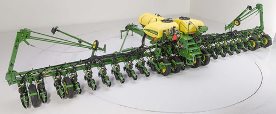 1775NT 24Row with frame weight distribution
1775NT 24Row with frame weight distribution
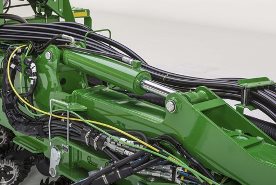 Hydraulic cylinder mounted on planter wings for frame weight distribution
Hydraulic cylinder mounted on planter wings for frame weight distribution
As planters get larger and more customizable, there is more weight being carried by the center mainframe. This presents the possibility that weight may not be distributed evenly along the width of the planter frame during planting in certain circumstances. Some studies have shown there could be a potential yield loss of 70.5 L (2 bu) per acre in certain soil conditions from unequal weight distribution with more weight being on the center of the planter. The option has been added to have hydraulic cylinders mounted onto the frame of the planter that redistribute weight from the center of the planter to the rest of the tool bar.
 Accumulator is mounted near the air compressor to absorb any spikes of pressure
Accumulator is mounted near the air compressor to absorb any spikes of pressure
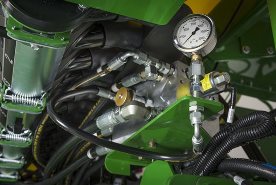 Hydraulic pressure can be adjusted from a valve block located under the Central Commodity System (CCS™) tank
Hydraulic pressure can be adjusted from a valve block located under the Central Commodity System (CCS™) tank
The frame weight distribution can be enabled or disabled on the Gen 4 4600 CommandCenter™ Display or 4640 Universal Display with SeedStar™ 4HP on MaxEmerge™ 5e or ExactEmerge™ equipped planters. MaxEmerge 5 equipped planters utilize an on/off switch by the valve block to enable and disable the system.
The system utilizes the tractor’s power beyond feature with load sense. Frame weight distribution is activated by the height switch, providing equal weight distribution at all times. In the scenario where a planter is equipped with frame weight distribution and onboard power generation for electric drives, there will be an orifice that directs hydraulic flow to fulfill the power generation requirement first and then provide oil to frame weight distribution.
Frame weight distribution is manually adjusted from a valve block below the CCS tank. The system does not have active adjustment capabilities. When the planter is raised on headland turns, the system maintains pressure to the outside wings for a period of time to keep the system engaged to make the turn and reduce center frame tire weight on headlands.
Available on the following models: 1775NT 24Row30 and all DB60 Planters (not available on the DB60T).
Features
SeedStar™ 4HP monitoring system
SeedStar 4HP is designed to optimize the in-cab monitoring experience exclusively on the Gen 4 4600 CommandCenter™ display or 4640 Universal Display for growers with ExactEmerge™ planters and MaxEmerge™ 5e planters model year 2018 and newer. With SeedStar 4HP, operators will easily see key planter information with customizable run pages, zoom functionality, and simultaneous graph and performance measurements. SeedStar 4HP is included in base on all model year 2018 ExactEmerge and MaxEmerge 5e planters.
Features overview:
- View multiple planters' at-a-glance bar charts simultaneously
- Three default planter run pages show key planter functions in easy-to-view layouts
- Highly configurable run pages allow SeedStar modules to be customizable
- Zoom feature allows quick row-by-row detailed information
- View dual bar graphs to see multiple planter details at one time
- SeedStar application to make adjustments to planter functions
- Simplified setup through the work set-up page
- Custom rates allow up to six different rates across 48 rows
- The SeedStar 4HP monitoring system requires the Gen 4 4600 CommandCenter or 4640 Universal Display. These displays allow the operator to benefit from the updated interface, enhanced processing speeds, and easy setup (learn more here).
SeedStar 3 HP conversion to SeedStar 4HP with mobile row-unit runoff aftermarket for field conversion kits
Growers who are currently running model year 2017 planters, model year 2017 and newer retrofit kits, or model year 2017 and newer custom-built planters with the SeedStar 3 HP monitoring system can upgrade to the SeedStar 4HP monitoring system with mobile row-unit runoff. The attachment part, AA100382, is software only. The Gen 4 display software version will need to be 19-1 or newer and will require planter apps. Follow the mobile runoff ordering and software push guide below for ordering and installation. Retrofitted planters and custom-built planters will also require the John Deere Connect Mobile kit, 0048PC, from the Precision Ag Technology Price Pages and wiring harness AA83662 to enable the mobile row-unit runoff feature. Please reference Parts Advisor and CCMS Solution 105181 for model-specific mounting brackets. SeedStar 4HP requires the Gen 4 4600 CommandCenter™ v2 display or 4640 Universal Display.
Default planter run pages
 Planter summary default run page
Planter summary default run page
 Planter overview default run page
Planter overview default run page
 Planter details default run page
Planter details default run page
Three default run pages show key planter functions in different views to give fast and easy access to important planter information.
Custom run pages
 Customizable run pages
Customizable run pages
There are customizable run pages that allow the operator to build pages that fit their operation with different modules, like the example shown above.
Zoom functionality
 Zoom feature showing a group of rows
Zoom feature showing a group of rows
 Zoom feature showing a single row
Zoom feature showing a single row
The zoom feature allows the operator to touch a section or row of the planter and get detailed information quickly.
Dual bar graphs
 Dual bar graph showing singulation and population simultaneously
Dual bar graph showing singulation and population simultaneously
Dual bar graphs allow operators to view multiple planter details at one time.
SeedStar application page
 SeedStar application run page
SeedStar application run page
In the SeedStar application, many adjustments can be made, including manually activating section control. SeedStar 4HP allows up to 48 individual row sections. There are several setup features such as crop, seed disk, number of rows being planted, population alarms, and limits. Seed rates can be modified, electric power generation (EPG) can be turned on or off, vacuum can be adjusted, and the fill and purge functions can be used from the SeedStar application. Frame control, as well as diagnostics and calibrations, can be accessed at the bottom of the screen.
Settings Manager in SeedStar 4HP
 Settings Manager screens
Settings Manager screens

Reduce set-up time between changing crops or field conditions by recalling saved settings used previously with Settings Manager, included with every SeedStar 4HP system. This feature allows saving and recalling planter and tractor settings for optimum performance in different conditions.
Settings Manager can be used to save all of the adjustment and inputs associated to a particular crop or condition. An example would be to store all population rates, downforce pressure, row cleaner adjustments, and closing wheel settings for planting corn and storing a separate, unique set of adjustments for soybeans. In addition, Settings Manager stores tractor settings such as selective control valve (SCV) flow and detents, infinitely variable transmission (IVT™) settings, eco modes, and more.
Custom rates in SeedStar 4HP
 Variety set-up page
Variety set-up page
 Rate set-up page
Rate set-up page
 Group rate set-up page
Group rate set-up page
Custom rates allow for individual row population control and row-by-row documentation where up to six different rates can be assigned across an up to 48-row planter. This allows growers interested in planting seed corn with ExactEmerge or MaxEmerge 5e the capability to assign specific populations to male and female rows for planting. This feature can also be used to create tram lines or other applications where custom rates by row are needed.
NOTE: Individual rates are tied to varieties, so each individual rate needs a unique variety name.
Compatibility
| SeedStar 4HP compatibility | |
| Planters | All models ordered with ExactEmerge or MaxEmerge 5e row-units NOTE: Retrofit kits are equipped with SeedStar 3HP only, but can be upgraded by purchasing part number AA100382. |
| Displays | Gen 4 4600 CommandCenter equipped with Version 2 Processor or 4640 Universal Display Dual-display mode is compatible with mid model year 2019 planter software. |
| Active Implement Guidance (AIG) | Compatible with SeedStar 4HP on Gen 4 displays with VT mode and required activations and subscriptions |
| AutoTrac™ Implement Guidance | Not compatible |
| AutoTrac Turn Automation | Not compatible |
Additional information
For additional information on feature functionality on the Gen 4 Display, visit the links below:
YouTube is a trademark of Google LLC.
Easy Fold

Easy Fold is a feature of SeedStar™ 4HP for MaxEmerge™ 5e row-units and ExactEmerge™ row-units equipped on 1775NT and 1795 Planters with a 2-point hitch or DB Planters. This integrated solution replaces the frame-folding box like the manual fold option in SeedStar 3 HP, and it has enhanced the process by controlling and automating the selective control valves (SCVs).
The one-operation fold reduces the need for training inexperienced operators by sequencing the process correctly and reduces time spent folding and unfolding. By utilizing implement automation, the hitch will be controlled by the planter during the fold cycle. Lining up the draft tube to the wing hooks is automated through this process, reducing operator tasks. On DB models, Easy Fold simplifies the folding process functions to one SCV. A manual process is available when needed.
A manual fold option is available from the frame control page on the display for non-compatible or non-equipped tractors or planters. The manual control function is accessible from each step of the Easy Fold process, as shown below.
 Manual control option on SeedStar 4HP
Manual control option on SeedStar 4HP
 Start screen for Easy Fold
Start screen for Easy Fold
 Screen with Easy Fold enabled
Screen with Easy Fold enabled
 Screen with Easy Fold in process
Screen with Easy Fold in process
 Easy Fold completed screen
Easy Fold completed screen
| Easy Fold compatibility | |
| Tractors |
|
| Activation | 2-point hitch equipped planters with Easy Fold require Tractor Implement Automation activation available from the StellarSupport™ portal. This activation is tractor PIN specific and non-transferable. Included in base on model year 2018 compatible tractors. See instructions below. |
| Planters | 1775NT and 1795 with 2-point hitch and DB Planters, equipped with ExactEmerge or MaxEmerge 5e row-units |
| Display | Gen 4 4600 CommandCenter™ Display or 4640 Universal Display |
NOTE: Included in base with ExactEmerge equipped compatible planters. Optional equipment on MaxEmerge 5e equipped compatible planters.
Tractor Implement Automation activation instructions
Use these instructions to download the Tractor Implement Automation activation code at no cost.
- Go to https://www.deere.com/en/stellarsupport/ or https://www.deere.ca/en/stellarsupport/
- Click Product Activation.
- Click Product Activation.
- Select Tractor Automation – Manage Product.
- Add or select existing tractor from list.
- Select the Activate button.
- Select Add Manufacturers drop down menu.
- Select Tractor Implement Automation – John Deere.
- Select Continue – Tractor Implement Automation – John Deere selected.
- Accept the Terms and Conditions.
- Select Finish.
- Take note of the code for use display.
- On the Gen 4 4600 CommandCenter Display or 4640 Universal Display select System, Software Manager.
- Select Activations, then Enter Code from John Deere Stellar Support.
- Enter activation code into the display in the tractor.
- Press next after activating Tractor Implement Automation.
- Take note of the activation code and press OK.
- The Tractor Implement Automation activation will appear the Software Manager screen.
NOTE: Prior to the 18.1 software release, the activation will be shown as “Unknown Implement 1” with a baler icon.
YouTube is a trademark of Google LLC.
Mobile row-unit runoff
 Row Runoff diagnostic test
Row Runoff diagnostic test
 The test functions from a mobile device
The test functions from a mobile device
 Determine optimum settings without being in the cab
Determine optimum settings without being in the cab
The first day of planting season can be as productive as the last with mobile row-unit runoff. The mobile row-unit runoff activation on the planter main controller (PMC) allows operators to make adjustments to maximize row-unit performance from a mobile device at the rear of the planter for both preseason and in-season use - all enabled through the PlanterPlus™ app.
Mobile row-unit runoff allows growers to perform test-stand functions from a mobile device connected to the planter.
The row runoff test provides complete diagnostic checks both preseason and in season. With the row-unit runoff test, the operator can make adjustments from the mobile device, including vacuum pressure, to determine the optimum meter and vacuum settings. This app functionality will help avoid making trips to the cab while validating meter performance.
During preseason planter inspections and set up, utilize the meter performance test to validate meter accuracy, similar to a test stand without leaving the farm. Test all systems on the planter, not just the meter, providing confidence that all planter systems are ready to plant. Reports are generated from the test providing information the operator can save and send for future reference.
Before heading to the field, the operator will benefit from knowing the best row-unit and vacuum settings for each variety selected to plant that spring.
Watch this video to see mobile row-unit runoff in action.
Mobile row-unit runoff will work with any model year 2015 or newer ExactEmerge™ or MaxEmerge™ 5e equipped planter. Mobile row-unit runoff can be added with attachment AA93169.
For model year 2018 and newer ExactEmerge planters, mobile row-unit runoff is included in base equipment. For model year 2018 and newer MaxEmerge 5e planters not equipped from the factory, mobile row-unit runoff can be added with attachment AA93169. A mobile row-unit runoff and Easy Fold package can be added with attachment AA97849 (only available with 1775NT and 1795 Planters with a 2-point hitch and model year 2019 and newer DB Planters with Gen 4 based frame folding).
NOTE: Mobile runoff utilizes PlanterPlus app available on select iPad® tablets, iPhone® smartphones, and Android™ devices.
Mobile row-unit runoff and Easy Fold aftermarket for field conversion kits
The below software bundles include the functionality explained above for machines not ordered with the feature from the factory. Compatible machines include all the necessary sensors and harnesses needed to make the feature function. The attachment part is software only. Follow the mobile runoff ordering and software push guide below for ordering and installation.
SeedStar™ 3 HP conversion to SeedStar 4HP with mobile row-unit runoff aftermarket for field conversion kits
Growers who are currently running model year 2017 planters, model year 2017 and newer performance upgrade kits, or model year 2017 and newer custom built-planters with the SeedStar 3 HP monitoring system can upgrade to the SeedStar 4HP monitoring system with mobile row-unit runoff. The attachment part, AA100382, is software only. The Gen 4 display software version will need to be 19-1 or newer and will require planter apps. Follow the mobile runoff ordering and software push guide below for ordering and installation. Performance upgraded planters and custom-built planters will also require the John Deere Connect Mobile kit, 0048PC, from the Precision Ag Technology Price Pages and wiring harness AA83662 to enable the mobile row-unit runoff feature. Please reference Parts Advisor and CCMS Solution 105181 for model-specific mounting brackets. SeedStar 4HP requires the Gen 4 4600 CommandCenter™ v2 display or 4640 Universal Display.
Mobile runoff ordering and software push guide
iPad and iPhone are trademarks of Apple Inc. Android is a trademark of Google LLC.
Downforce system options

Heavy-duty adjustable downforce springs
 Heavy-duty adjustable downforce spring
Heavy-duty adjustable downforce spring
Planter row-unit downforce is an important factor to ensure consistent and proper depth control. The heavy-duty adjustable downforce feature provides up to 181.4 kg (400 lb) of downforce. There are four settings available to allow the operator to choose the amount of downforce required for the condition: 0 kg (0 lb), 56.7 kg (125 lb), 113.4 kg (250 lb), and 181.4 kg (400 lb).
Compatibility: 1705, 1715, 1725, 1735, 1755, 1765, 1765NT, 1775 Flex, and 1785
Standard pneumatic downforce system
Pneumatic downforce provides convenient, simple adjustment of downforce for the whole planter from one location. The amount of downforce applied is infinitely adjustable from 0 to 181.4 kg (0 to 400 lb). Pneumatic downforce provides more consistent downforce throughout the range of row-unit travel than mechanical spring downforce systems.
Features include:
- 9.5-mm (3/8-in.) air delivery line instead of the 6.4-mm (1/4-in.) line used on model year 2010 and older planters.
- Air compressor assembly increased duty cycle. With this compressor, it provides a 47 percent increase in maximum air flow delivery compared to the prior air compressor.
- Pneumatic air bags with 9.5-mm (3/8-in.) air line inlets that have greater durability.
 Pneumatic downforce spring
Pneumatic downforce spring
Each row-unit has a single rubber air bag located between the parallel arms. The air bags are hooked in parallel so that air can be added or released from all rows at once from one location.
The individual pneumatic downforce air bag assemblies, air compressor units, and 9.5-mm (3/8-in.) delivery lines are also available as an attachment for field conversion.
 Pneumatic downforce compressor and gauge
Pneumatic downforce compressor and gauge
An improved compressor is used to charge the pneumatic system. This compressor can be located on the planter frame or in the tractor cab if desired. A gauge at the compressor indicates the amount of downforce being applied.
From the factory, integral planter models with pneumatic downforce will have an improved air compressor assembly with an in-cab mounting bracket, except for the 1725 16-row and 1725 Central Commodity System (CCS™) twin-row planters, which will have the air compressor assembly mounted on the planter frame. For drawn planter models, the 1755, 1765, 1765NT, 1775 Front-Fold, and 1785 Drawn Planters will have the air compressor assembly installed either on the outer hitch or wing frame members when the pneumatic downforce system is installed.
Base equipment on: 1705, 1715, 1725, 1735, 1755, 1765, 1765NT, 1775 and 1785.
Integrated pneumatic downforce system
The functional features of the integrated system are the same as the standard pneumatic system, explained above, with the addition of control through the GreenStar™ display.
System control with the GreenStar display
 Pneumatic downforce control in GreenStar 2 Display
Pneumatic downforce control in GreenStar 2 Display
 Air compressor mounted on 1775NT outer hitch
Air compressor mounted on 1775NT outer hitch
On 1725 16-row, 1725 CCS TR, 1775NT, 1775NT CCS, 1795, DR, and DB Series Planter models, the air compressor will be mounted on the outer hitch or frame assembly. Since the air compressor assembly is mounted on the outer hitch (as noted in the picture above) or frame, adjustments for row-unit downforce and related system pressures will be made electronically with the GreenStar display.
When adjusting the amount of row-unit downforce using the GreenStar display, the operator will select the amount of downforce (kg [lb]) to be applied across the planter. Depending on the soil conditions at hand, the operator might need to adjust the relative amount of row-unit downforce being applied during the planting operation. The integrated pneumatic downforce controls within the GreenStar display will only allow for set-point operation and not automatic control as the planter is operating in different soil conditions. The pneumatic downforce system does not have the capability to automatically adjust downforce.
On-board air storage
 Onboard air storage installed on 1775NT 24R30
Onboard air storage installed on 1775NT 24R30
The 1725 16-row, 1725 CCS TR, 1775NT, 1775NT CCS, 1795, DR, and DB Series planters will have onboard air storage to increase the overall response time when making a row-unit downforce adjustment from the GreenStar display. The onboard air storage is comprised of a 18.9-L (5-gal.) storage tank with valve assembly.
Base equipment on: 1725 CCS, 1725 16-row, 1725T, 1775NT, 1775NT CCS, 1795, DR, and DB Series Planters with MaxEmerge™ 5 row-units. MaxEmerge 5e and ExactEmerge™ equipped planters come with active pneumatic downforce in base.
Active pneumatic downforce
 Active downforce compressor assembly
Active downforce compressor assembly
 Hydraulic motor
Hydraulic motor
A hydraulically driven compressor works with the SeedStar™ 3 HP system and SeedStar XP system to automate downforce control. Just set the row-unit target margin value and the active pneumatic downforce system works automatically. The system will make sure the planter maintains this value, achieving precise soil penetration, and consistent planting depth, without sidewall soil compaction. From the factory, the system is set at 45.4 kg (100 lb) target downforce margin, but may be modified for varying field conditions. This frees the operator from constantly making manual downforce adjustments as conditions change.
This system offers a split-rank control feature for 1795 and DB Split-Row Planters. On split-row planters, active downforce will control the front and rear rows independently. This compensates for differing downforce requirements between the ranks that can be caused by things like different tillage or insecticide attachments and will help maintain an accurate planting depth and consistent margin across all the rows.
Active pneumatic downforce is available as factory installed or as an attachment for field conversion.
SeedStar XP row-unit downforce planter run page
 SeedStar XP downforce planter run page
SeedStar XP downforce planter run page
Active downforce control is integrated into SeedStar XP and SeedStar 3 HP monitoring systems.
Margin is the amount of weight riding on the depth gauge wheels that ensures desired firming of the seedbed as set by the operator.
Once a target margin has been defined, enter the value into SeedStar XP or SeedStar 3 HP and let active downforce do the rest. The system will actively adjust the air pressure in the air bags to maintain a constant margin across the planter. The changes in air pressure will change the amount of downforce placed on the row-unit, compensating and reacting for varying conditions through the field whether it is different tillage practices, soil types, or moisture.
 Downforce and margin example
Downforce and margin example
- A - Margin – amount of additional downforce applied to a row-unit above and beyond what is required for penetration to achieve planting depth. This additional weight will ride on the depth gauge wheels. 54.4 kg (120 lb) + 36.3 kg (80 lb) = 90.7 kg (200 lb) – 68 kg (150 lb) = 22.7 kg (50 lb) of margin
- B - Weight of row-unit - 54.4 kg (120 lb)
- C - Downforce – force that is applied to the row-unit by the air bag circuit - 36.3 kg (80 lb)
- D - Resistance from soil - 68 kg (150 lb)
Hydraulically driven compressor
 Hydraulic motor
Hydraulic motor
 Pneumatic valve
Pneumatic valve
The hydraulically driven air compressor can deliver up to eight times the air flow, allowing for more and faster downforce changes to be made. This more robust design features a 37.8-L (10-gal.) storage tank across all models with active downforce.
At approximately 15.1 L/min (4 gpm), hydraulic demands are low and ties into the machine’s lift and CCS hydraulic circuit so it does not require any additional selective control valves (SCVs). The SeedStar XP and SeedStar 3 HP monitoring systems work with the compressor and valve assembly to regulate air to downforce springs, enabling the active control.
Another feature of John Deere active downforce is the ability for the pneumatic valve to independently control split-rank machines. This system senses the downforce needs from the front and rear ranks separately and independently adjusts air pressures with the dual-rank pneumatic valve when equipped. Active pneumatic downforce requires SeedStar XP or SeedStar 3 HP to enable active control.
Base equipment on: All MaxEmerge 5e and ExactEmerge equipped planter models.
Individual Row Hydraulic Downforce (IRHD)

IRHD has been specifically designed to meet the needs of producers that are looking to adjust to the toughest field conditions and provide maximum yield potential from field to field, season after season. IRHD works as a closed-loop downforce system that reacts quickly on an individual row basis to changing soil conditions supporting increased ground contact, which can lead to improved seed depth consistency. When setting planter downforce margin, the system will apply the needed downforce by row to maintain ground contact. From the factory, the margin will be set at 45.4 kg (100 lb), changes may be required based on varying field conditions.
The system allows operators to maintain gauge wheel ground contact leading to desired seed depth placement. IRHD can adjust five times per second and make adjustments of 45.4 kg (100 lb) in less than a second. The system has a total range of applied downforce from 22.7 kg (50 lb) to 204.1 kg (450 lb) and utilizes the power beyond circuit on the tractor. IRHD is 58 percent faster than the active pneumatic downforce solution. Fast reaction and increased ground contact can lead to improved emergence. With uniform emergence, some studies have shown a yield impact from 5 percent to 9 percent.
IRHD is controlled through the Gen 4 4600 CommandCenter™ Display or 4640 Universal Display with SeedStar 4HP. As shown below, operators can view ground contact or applied downforce using the toggle button.
 IRHD screen showing the ground contact graph
IRHD screen showing the ground contact graph
 IRHD screen showing the applied downforce graph
IRHD screen showing the applied downforce graph
Optional equipment on: 1775NT, 1795, DB, and Orthman custom models with MaxEmerge 5e and ExactEmerge row-units.
Easy Adjust row cleaners
 Coulter combo row cleaner
Coulter combo row cleaner
 Easy Adjust row cleaner
Easy Adjust row cleaner
Easy Adjust row cleaner and coulter combo provides a pneumatic row tillage solution that is controlled from the seat of the tractor.
Every decision to make an adjustment during spring planting reduces the acres planted per day and can increase or decrease profitability. An adjustment that can be overlooked is row cleaners due to planter size, difficulty to make the adjustment, and varying conditions across fields and time.
 GreenStar™ 3 2630 Display view for row cleaners compatible with SeedStar™ 3 HP
GreenStar™ 3 2630 Display view for row cleaners compatible with SeedStar™ 3 HP
 4600 CommandCenter™ Display and 4640 Universal Display view for row cleaners compatible with SeedStar 4HP
4600 CommandCenter™ Display and 4640 Universal Display view for row cleaners compatible with SeedStar 4HP
With the Easy Adjust row cleaners on ExactEmerge™ planters, operators now have a pneumatic solution to make on-the-go adjustments that is controlled directly from the seat of the cab. They can be raised from the cab as needed with the push of a button for wet areas, waterways, or end rows. For growers using SeedStar 3 HP, the row cleaners are completely integrated into the John Deere GreenStar 3 2630 Display as well as the Gen 4 4600 CommandCenter display or 4640 Universal Display. For growers using SeedStar 4HP, a 4600 CommandCenter display or 4640 Universal Display is required.
The Easy Adjust row cleaners have the capability to save three presets for varying ground engagement based on field conditions. The system is controlled in three sections: at each wing as well as the center (frame or wheel) track rows. The pneumatic lines use air from the active pneumatic downforce compressor, requiring no additional compressor to be installed on the planter. The Easy Adjust row cleaners utilize down and up force air bags. The adjustable air pressure setting for each bag allows the operator to set the ride of the row cleaner depending on the field conditions and the desired results. Making these on-the-go adjustments from tractor cab increases productivity and performance during planting.
For Easy Adjust row cleaner performance upgrade kit options, see the ordering guide.
The row cleaner-only option utilizes parallel linkage to provide the floating action growers require in their fields. Parallel linkage allows for the unit to float up and down in the situation of hills or hard objects. The cleaner and coulter combo does not have parallel linkage, however, the row cleaners have floating rings installed to help provide the same benefits.
The row cleaners utilize the field-proven SharkTooth® design. Row cleaners play a major role in maximizing yield toward uniform emergence, reducing row-unit bounce, and maintaining proper depth. The Easy Adjust row cleaners provide growers with quick and stress-free solutions to customizing the planter in variable field conditions. They are available on ExactEmerge and MaxEmerge 5e equipped planters. They are not integrated into the RowCommand™ feature.
SharkTooth is a trademark of Yetter Manufacturing Incorporated.
Pneumatic closing wheels

Pneumatic closing wheels are compatible with MaxEmerge™ 5e and ExactEmerge™ row-units. They are available on the following models from the factory: 1775NT, 1795, and DB60 models. The pneumatic closing wheels give operators the ability to adjust closing wheels in seconds without leaving the cab of the tractor.
Using the GreenStar™ 3 2630 Display, pneumatic closing wheels can be adjusted to 25 different positions. From the factory the system is setup with two sections, the outer wings and center frame. With this system, producers will see up to a 76 percent increase in consistent force applied at the closing wheel. Consistently applying the correct force at the seed trench is one of the key elements of supporting improved emergence. Studies show potential yield impact on corn from even emergence from 5 percent to 9 percent*.
NOTE: Pneumatic closing wheels can be purchased for existing MaxEmerge 5e and ExactEmerge planters as an aftermarket field kit. Both rubber tire and cast-iron closing wheels are compatible.
Access the pneumatic closing wheels attachment for field conversion (AFC) ordering guide to fit a 1725 CCS, 1775NT, 1795, or DB60 Planter.
*Planting Outcome Effects on Corn Yield: Doerge, Tom, Jeschke, Mark and Carter, Paul
Curve compensation

Terraces or waterways are two of many field obstacles that make planting on a curve challenging. When planters utilize drive shafts, they are not able to control each individual row-unit; as a result, planting on a curve presents an issue of maintaining 100 percent population. Since the inside rows are moving slower than the outside rows, the inside rows will be over populating while the outside rows are under populating.
With ExactEmerge™ planters and equipped MaxEmerge™ 5e planters, the curve compensation feature allows each row to receive an individual signal based on the speed at which the row-unit is moving, maintaining the correct population across the width of the planter. Without curve compensation, there could be as much as a 24 percent drop in population accuracy, which is equivalent to 8,600 seeds per acre when planting at 36,000 seeds per acre. Curve compensation measures acceleration within the main planter controller and utilizes speed inputs to ensure each row has the desired population accuracy.
Row cleaner options to meet residue management needs
Crop yields have increased through the years along with the amount of residue left in the field after harvest. At the same time, tillage practices have changed, including different tillage operations which maintain large amounts of surface residue, and even no-till practices. Row cleaners are an essential tool in managing this increased amount of residue.
John Deere seeding group offers a variety of row cleaner options to meet the needs of a producer's operation. Compatibility varies by model, row spacing, and other planter equipment.
Screw-adjust, unit-mounted row cleaner
 Screw-adjust, unit-mounted row cleaner
Screw-adjust, unit-mounted row cleaner
The screw-adjust, unit-mounted row cleaner is mounted directly to the face plate of the row-unit, placing the ground engaging components just in front of the row-unit opener blades and depth gauge wheels. This close proximity allows the gauge wheels to control the depth of the row cleaner as well as the row-unit. This compact design also allows greater compatibility with fertilizer openers and other planter attachments.
SharkTooth® wheels are standard equipment on the unit-mounted row cleaner. The swept-tooth design of the wheel provides a clear path for the row-unit openers while resisting residue buildup on the wheel. The screw adjustment knob is accessible through the top of the parallel arms, providing convenient access for adjustments. The row cleaner can be adjusted in 1.6-mm (1/16-in.) increments, providing plenty of flexibility to meet the needs of changing conditions.
Floating row cleaner with unit-mounted coulter
 Floating row cleaner with unit-mounted coulter
Floating row cleaner with unit-mounted coulter
The floating row cleaner allows a row cleaner to be used in conjunction with a unit-mounted coulter. This combination is often desired in heavy residue loads and reduced tillage planting conditions. The row cleaner provides a clear path for the row-unit, while the unit-mounted coulter helps penetrate tough soil conditions.
Accommodating the unit-mounted coulter means the residue wheels are farther forward from the row-unit face plate than in the case of the screw-adjust row cleaner. To maintain performance, this row cleaner has the capability to float above a defined minimum depth.
Standard depth-gauging bands on the wheels allow the row cleaner wheels to float independently of the row-unit openers, allowing both to perform in varying terrain. The unit may also be set in a fixed position by simply pinning through the bracket if desired. This row cleaner also features SharkTooth wheels as standard equipment.
The floating row cleaner and unit-mounted coulters are available on many planters as factory-installed equipment. As compatibility and details vary by model, review the following links for information on specific planter models.
NOTE: Screw-adjust row cleaners are not compatible with MaxEmerge™ 5e row-units with long parallel arms.
NOTE: DB models have the option for either unit-mounted coulter, screw-adjust row cleaners, or pneumatic row cleaners (only compatabile with MaxEmerge 5e or equipped ExactEmerge™ models). The DB60T is only available with a less row cleaner option.
SharkTooth is a trademark of Yetter Manufacturing, Inc.
RowCommand™ individual-row control system
RowCommand controls seed output
 RowCommand on a MaxEmerge™ 5 row-unit
RowCommand on a MaxEmerge™ 5 row-unit
 RowCommand on a chain drive MaxEmerge 5 row-unit
RowCommand on a chain drive MaxEmerge 5 row-unit
Controlling input costs and improving productivity are key producer requirements today. RowCommand is an effective, integrated John Deere solution designed to meet these intensifying needs. The RowCommand system manages seed output, reduces yield drag, and improves harvest capabilities on all Pro-Shaft™ driven row-units, and chain-driven MaxEmerge 5.
NOTE: Chain-drive RowCommand is only compatible with planters equipped with pneumatic downforce systems. On planters equipped with the heavy-duty downforce springs, potential chain interference may result and is not recommended.
NOTE: Chain-drive RowCommand requires some modification to brackets in order to function with corn finger pickup meters.
NOTE: Pro-Shaft drive RowCommand is compatible on MaxEmerge 5 row-units with vacuum and corn finger pickup meters. For mini-hopper row-units, RowCommand is compatible on vacuum meters only and is not compatible on corn finger pickup meters. Pro-Series™ XP row-units with corn finger pickup meters are not compatible with RowCommand.
RowCommand controls seed output by incorporating individual, low amperage clutches inside the Pro-Shaft and chain-driven gearboxes. Clutches are completely enclosed within the gearbox housing to protect them from the elements and harsh operating conditions.
When power is supplied, either manually or through John Deere Section Control software, clutches disengage the seed meters and seed flow stops. Controlling seed output at individual rows reduces overplanting in point rows and maximizes seed placement when entering/exiting headlands.
Components and operation
 Electronic power modules shown on a 1775NT Planter
Electronic power modules shown on a 1775NT Planter
 RowCommand clutch on MaxEmerge 5 with 105.7-L (3-bu) hopper
RowCommand clutch on MaxEmerge 5 with 105.7-L (3-bu) hopper
RowCommand is a simple and efficient solution to control individual row planting. This system does not utilize air to operate; therefore, no compressor, air lines, or valve modules are required.
RowCommand utilizes low-voltage controller area network (CAN) messaging to signal power to the desired clutches to stop planting or eliminates power to resume planting.
This means very little power is used in normal planting conditions, and in the event a clutch fails electrically, the meter will continue to plant.
The RowCommand system requires the following five basic components to operate:
-
Electric clutches
-
Electronic power modules (EPMs)
-
SeedStar™ 2 monitoring (wedge box/controller)
-
GreenStar™ (GS) display
-
Planter wiring harnesses
Clutches are protected within the sealed Pro-Shaft and chain-driven gearboxes for years of trouble-free operation and simple installation or removal. RowCommand has true individual-row control of up to 16 clutches or sections for planters larger than 16 rows.
Unique to RowCommand, the 16 available control sections can be configured based on operator preferences. For example, on a 1775NT 24-Row Planter, every two rows can be paired together for a total of 12 control sections, or control the outermost eight rows individually and the remaining inner rows paired together for 16 control sections.
While SeedStar with RowCommand has 16 control sections, a minimum of 152.4-cm (60-in.) wide sections are recommended for optimum Swath Control Pro™ solution capabilities. As with other Swath Control Pro products, an SF2 signal is the minimum level of accuracy recommend for operation.
Pro-Shaft drive RowCommand planters
RowCommand is available as a factory-installed option or as an attachment for field conversion attachments for the following Pro-Shaft drive planter models (see chart below).
| Planter model | Row configuration |
| 1725 | 12-row narrow, 12-row wide, and 16-row narrow |
| 1725 Central Commodity System (CCS™) | 16-row narrow |
| 1765 | 12-row narrow |
| 1775 | 12-row narrow |
| 1775NT | 12 row, 16 row, and 24-row narrow |
| 1775NT CCS | 12 row, 16 row, and 24-row narrow |
| 1795 | 12/23 row, 12/24 row, 16/31 row, and 16/32 row |
| 1795 | 24 row, 50.8 cm (20 in.) |
| DB 44 | 24 row, 55.9 cm (22 in.) |
| DB 58 | 32 row, 55.9 cm (22 in.) |
| DB 60 | 36 row, 50.8 cm (20 in.) or 47 row, 38.1 cm (15 in.) |
| DB 66 | 36 row, 55.9 cm (22 in.) |
| DB 80 | 32 row, 76.2 cm (30 in.) or 48 row, 50.8 cm (20 in.) |
| DB 88 | 48 row, 55.9 cm (22 in.) |
| DB 90 | 36 row, 76.2 cm (30 in.) |
| DB 120 | 48 row, 76.2 cm (30 in.) |
| DR (Deere/Orthman™ planter) 16R40 | 16 row, 101.6 cm (40 in.) |
| DR (Deere/Orthman) 18R38 | 18 row, 96.5 cm (38 in.) |
Chain-drive RowCommand planters
In terms of planter compatibility, RowCommand for chain drive is designed for the following planter model configurations equipped with pneumatic downforce systems.
| Planter model | Row configuration |
| 1725 | 12-row narrow, 12-row wide, and 16-row narrow |
| 1765 | 12-row narrow |
| 1775 | 12-row narrow |
| 1775NT | 12 row and 16 row |
| 1775NT CCS | 12 row and 16 row |
| DB 44 | 24 row, 55.9 cm (22 in.) |
Chain-drive RowCommand and heavy-duty downforce
 Chain interference with heavy-duty downforce
Chain interference with heavy-duty downforce
As seen in the image, chain interference may result when operating chain-drive RowCommand on planters equipped with short and long parallel arms and heavy-duty downforce springs.
NOTE: Chain-drive RowCommand is only compatible with planters equipped with pneumatic downforce systems. On planters equipped with the heavy-duty downforce springs, potential chain interference may result and is not recommended.
Chain-drive RowCommand with corn finger pickup meters
 Bracket material removal
Bracket material removal
Due to the design characteristics of the chain-drive RowCommand clutch, some modification to the corn finger pickup meter drive bracket is required. As seen in the picture to the left, some material needs to be removed from the front of the meter drive bracket in order for the chain-drive RowCommand clutch to have sufficient space for installation.
NOTE: Chain-drive RowCommand requires some modification to brackets in order to function with corn finger pickup meters.
RowCommand ordering information
To add RowCommand to a model year 2009 and newer planter model listed above is simple. Pro-Shaft drive attachments for field conversion and chain-drive attachments for field conversion are available by planter model to add the appropriate number of clutches, EPMs, brackets, hardware and row-unit harnesses. For complete installation and part detail for the RowCommand conversion, please use the RowCommand compatibility tool per specific planter model.
RowCommand is compatible and available for model year 2003 (serial number 700101) to 2008 (725101) planter models listed above. In addition to the attachment for field conversion attachment, a planter mainframe harness, SeedStar 2 controller (wedge box), and additional CAN harnesses are needed.
Integrated Swath Control Pro
Coupling RowCommand with Swath Control Pro provides the ultimate in precision planting and productivity. One company, one integrated solution are what we offer by incorporating Swath Control Pro capabilities within the SeedStar 2 wedge box (controller). Unlike previous systems, no rate controller, additional harnessing, or components are required to achieve automated individual-row control.
SeedStar 2 monitoring, RowCommand, and Swath Control Pro activation from John Deere Precision Ag Technologies are all that is needed when ordering.
System requirements
RowCommand is a simple and efficient means to control individual row planting through the use of low-voltage electric clutches. When activated, each clutch consumes no more than 0.5 amps. By design, power is only supplied to the clutch when a signal is received to stop planting. In a normal planting condition, no power is supplied and the clutch is de-energized.
Power for the RowCommand system is provided from the 9-pin ISO implement connector. All late-model 8X00 and 9X00 Series John Deere Tractors equipped with the 9-pin ISO implement connector are capable of supplying ample power for system operation.
Along with ample system power, a GreenStar display and SeedStar monitoring are required for operation and control interface. The GreenStar display is where system setup, control settings, and manual control functions are performed.
Seed variable-rate drive (VRD) with half- or three-width disconnect
 VRD shown on a 1775NT
VRD shown on a 1775NT
The seed variable-rate drive provides the ultimate planting productivity by utilizing one, two or three hydraulic motors (varies by model) to turn the seeding drive shaft. Hydraulic control of the seeding drive allows for on-the-go seeding rate changes right from the display mounted inside the tractor cab.
Combine this seeding flexibility with the map-based planting option, and seeding rates adjust automatically based on a prescription map.
Single- or dual-motor systems for variable-rate drives are available for all John Deere planters except the 1785 Rigid Frame. Dual- or three-motor drive systems are commonly used on larger (12-row and more) planters and offer the capability of half-width or three-section drive disconnect.
The VRD is available as a factory-installed option for all applicable planter models. Single- or dual-motor systems are available as field-installed attachments for most planter models; however, a three-motor VRD field-installed attachment is not available.
The seed VRD requires the SeedStar™ monitor and a radar input signal. Either tractor or planter radar may be used. Planter radar is ordered separately.
VRD offers the following advantages over common, contact-tire drive systems:
-
Almost instantaneous rate changes – there is no ramp up or ramp down of system as in some competitive systems
- Permits the operator to match seed population based on different soil types or irrigation practices
- John Deere design that provides added operator safety by eliminating any possible drive creep found in some competitive variable rate drive systems
Half-width drive disconnect
The half-width drive disconnect feature is excellent for the producer concerned with controlling seed costs. This feature helps the operator place seed in the desired area and limit the amount of costly overlapped planting.
The half-width drive disconnect allows the operator to turn off half of the planter at a time for planting end rows, point rows, etc. Variable-rate-equipped planters require two drive motors to utilize the half-width disconnect feature.
 Half-width drive disconnect within frame control
Half-width drive disconnect within frame control
With a 1765, 1765NT, and 1775 12-Row Planter, a single switch box is required for planters that are ordered with variable rate drive and half-width disconnect.
For the 1775NT, 1775NT Central Commodity System (CCS™), and 1795 Front-Folding Planters, the half-width drive disconnect switch is contained within the frame control box, conveniently located in the tractor cab. The function easily shuts off the drive for the left or right half of the planter row-unit seed meters.
Three-width drive disconnect
 Three-width drive disconnect control
Three-width drive disconnect control
Three-width drive disconnect is an option on 1725 12-Row Planters and is base equipment on the 1725 16Row30 Planter. This feature is activated by three individual console mounted switches (control box), conveniently located in the tractor cab. The function easily shuts off the planter row-unit seed meters by one-, two-, or three-drive segments independently.
Drawbar hitch
 Drawbar hitch
Drawbar hitch

A factory-installed, optional drawbar hitch is available for use with 1775NT 16- and 24-Row, 1775NT Central Commodity System (CCS™) 16- and 24-Row, and 12.2-m (40-ft) 1795 Planters. For all DB models the drawbar hitch is in base. All DB models are available with Category 5 drawbar hitch. The following DB models are not available with Category 4 drawbar hitch: DB80 48R20, DB88 48R22, DB90 36R30, DB90 54R20, and DB120 48R30.
The planter drawbar hitch provides easy operation with plenty of ground clearance. The hitch design utilizes a hydraulic cylinder to raise the planter hitch for transport. Hydraulic oil for the hitch cylinder on 1775NT and 1795 Planters comes from the row marker system. Activation of this cylinder is accomplished using a single switch on the display and the marker selective control valve (SCV).
Due to the hydraulic system design, the drawbar hitch requires the planter be equipped with independent markers (not tied to planter lift circuit). Removal of markers from all planters, except the 1775NT 24Row30, makes the drawbar hitch inoperable. The 1775NT 24Row30 is the only planter where the drawbar hitch, less markers, is a valid combination.
For planting on 38.1-cm (15-in.) row spacing with a 16/32-Row 1795 Planter, the drawbar needs to be offset 19-cm (7.5-in.) on the tractor to center the planting rows behind the tractor. When the 16/32 1795 has a drawbar hitch, operators may not be able to offset the hitch to the exact specifications of 19-cm (7.5-in.) when planting in 38.1-cm (15-in.) operation, and could be off as much as a 1.3-cm (0.5-in.). To compensate, additional adjustments to the marker will be necessary.
When using a guidance system such as parallel tracking or AutoTrac™ assisted steering system, operators will need to use their implement offset when planting with all rows on 1795 Planters equipped with the drawbar hitch to compensate for the offset.
The drawbar hitch is ideal for those who have 9000 Series Tractors without a 3-point hitch. For these, the planter drawbar hitch is the economical choice instead of adding a 3-point hitch.
To accept the planter drawbar hitch, the tractor drawbar must be ordered with, or upgraded to, a Category 4 drawbar with the heavy-duty package or Category 5 to be compatible. Track tractors with wide-swinging drawbars are not compatible with the planter drawbar hitch due to a lower hitch-load capacity.
Each 1795 or 1775NT Planter ordered with the drawbar hitch will be shipped with a Category 4 hitch link installed. A Category 5 hitch link is also shipped with the planter if the planter is to be used with a Category 5 drawbar. See pre-delivery instructions included with the planter for changeover information.
Compatibility:
- Category 5 implement hitch links are not compatible with Category 4 tractor drawbars.
- Category 5 tractor drawbars are not compatible with Category 4 implement hitch links.
This hitch also adds 0.6-m (2-ft) to planter length during transport and field operation. There are some combinations of planter options that are not compatible with the drawbar hitch option due to tractor drawbar limitations.
DB fertilizer options
Option code 2625 – Liquid fertilizer with row-unit mounted in-furrow applicator:
- This option contains a ground driven pump, plumbing to a manifold, and routing to each row-unit. The in-furrow applicator places fertilizer after the seed and before the closing wheels.
The DB60 24Row Split 47 Planter and DB60 24Row Split 48 Planter applies fertilizer on 76.2-cm (30-in.) row spacing only.
Central Commodity System (CCS™) seed delivery system
 CCS
CCS

CCS seed delivery adds productivity through increased seed capacity, bulk fill capability, and easy, thorough cleanout.
The two tanks have a combined capacity of 2466.7 L (70 bu) on 9.1-m (30-ft) planters and 3523.9 L (100 bu) on 12.2-m (40-ft) and larger planters. CCS tanks are manufactured using a rotomolded, polyethylene design to ensure maximum durability. The translucent tanks allow easily viewing the amount of seed in the tanks. The tanks are separated by 54.6 cm (21.5 in.) for enhanced rear visibility during transport and backing.
The following crops can be planted with CCS: corn, sweet corn, popcorn, cotton, sunflowers, sugar beets, soybeans, and sorghum (milo).
Filling the tanks is convenient due to a central filling location. The staircase and railing provide access to the filling platform between the tanks. If filling the tanks with an auger, minimum recommendations are a 15.2-cm (6-in.) diameter, 4.3-m (14-ft) auger. Each tank has an adjustable bin-level sensor to alert the operator when it is time to fill.
A standard fill light package is available on machines equipped with CCS. This feature includes two lights conveniently mounted on the railings of the machine. The lights are turned on and off with their own switch located at the bottom of the staircase.
If the seed-carrying vehicle requires hydraulic power to run the unloading system, the auxiliary hydraulic coupler option is available. These couplers are located at the bottom of the staircase and can be coupled under pressure. The system has a separate system filter that ensures the planter hydraulic system remains free of contaminates.
Seed delivery process
CCS is about reducing the time spent filling the planter with seed while maximizing the time spent planting. CCS for planters is a form of seed handling and delivery. The row-units perform the final task of seed metering and placement.
The CCS seed delivery process relies on a hydraulically-driven fan to move seed from the CCS tanks to the row-units. This fan is plumbed in to the planter's raise/lower circuit, so only one selective control valve (SCV) is needed for both functions. When the planter is lowered, lift cylinders bottom out and hydraulic flow is diverted to the seed delivery fan. A flow control valve and gauge, located near the tank, allows for the proper tank pressure setting based on seed type.
Air from the fan pressurizes the CCS tanks and delivers seed to the seed hoppers. Airflow enters the seed tanks through a nozzle in the manifold which pressurizes the tank. The air then picks up seed and moves it out the other end of the nozzle into seed delivery hoses. These hoses route the seed toward the hopper. A small amount of seed is traveling in the delivery hoses only when needed.
The hopper fills with seed until the delivery hose (discharge elbow) is covered. Once the opening is restricted, seed flow through the hose stops. Air flowing to the row-unit travels into the hopper and is the source of air for the vacuum system. This provides a much cleaner air source than previous meter designs. As the seed is picked up by the meter and planted, the seed pool shrinks until the end of the delivery hose is uncovered. At that time, the airflow and seed delivery resume and the seed pool in the hopper is replenished.
CCS tank scales for DB Planter models
The CCS tank scales for DB models are a stand-alone system from Digi-Star®. Load cells are installed at the factory and can be ordered for CCS or CCS with Refuge Plus.
There are three load cells, two at the rear of the CCS cradle and one at the front. They weigh both tanks as one; individual tank weights cannot be determined.
The load cells and display are made by Digi-Star. They are not on the controller aread network (CAN) bus system so they are not integrated into SeedStar™ software in any way. The monitor is sold separately through Digi-Star.
CCS seed cleanout
Seed cleanout could not be much easier with a CCS planter. When finished planting, any remaining seed can simply be removed via access doors at the bottom of the CCS tank.
Because seed is only traveling through the CCS delivery hoses when required by the meter, there is not much left to clean.
CCS seed delivery hoses are then purged with air from the CCS fan, and the excess seed is pushed to the individual meters. The vacuum meter door is opened and seed is removed with the supplied catch pan.
Small seed CCS components
 Manifold nozzle and nozzle with cover installed
Manifold nozzle and nozzle with cover installed
 Straight seed inlet installed in mini-hopper
Straight seed inlet installed in mini-hopper
CCS seed delivery system increases planting productivity across the seven approved crops listed above. While highly effective delivering seed from the CCS tanks to the vacuum meters, small or light seeds (sorghum and small cotton) will require two additional components to aid in proper seed delivery.
Manifold nozzle covers (clips) should be installed to ensure seed is adequately picked up into the air stream for delivery to the row-unit. Mini-hopper discharge elbows should also be changed from the standard elbow (holes) to the small seed elbow (slotted openings) when planting sorghum (milo) and small cotton.
Digi-Star is a trademark of Digi-Star LLC.
Provide added versatility and productivity with Central Commodity System (CCS™) Refuge Plus planter configuration

DB44, DB60, DB60T, DB66, DB80, DB88, DB90, and DB120 Planters can be equipped with the Refuge Plus option from the factory.
The third tank on the Refuge Plus system provides increased versatility and productivity to the planting operation by allowing the grower to plant two different varieties simultaneously. The Refuge Plus tank has manifold nozzles, or outlets, to supply seed to eight different row-units.
Refuge Plus is ideal for the grower planting Bt corn or seed corn. Refuge Plus is the solution for refuge management compliance issues associated with Bt corn production. The 881-L (25-bu) capacity of the third tank makes planting the required 20 percent refuge of non-Bt corn easier while maintaining high productivity levels of the central-fill CCS.
For example, Bt corn planted on 80 percent of the field goes into the larger CCS tanks. The required 20 percent refuge, non-Bt corn, goes into the third Refuge Plus tank with the seed hoses routed to the desired rows.
Central fill with CCS is easier for the seed-corn grower as well. The seed-corn grower can plant both male and female seed in the desired pattern simply by placing the male seed in the Refuge Plus tank, the female seed in the CCS tanks, and routing the seed delivery hoses to the desired row units.
NOTE: Only DB44, DB60, DB60T, DB66, DB80, DB88, DB90, and DB120 Planters can be equipped with the Refuge Plus option from the factory. Other CCS equipped models can add Refuge Plus through Parts.
Redirecting seed delivery
 Seed delivery hose connection and yellow plug
Seed delivery hose connection and yellow plug
Redirecting seed delivery from the CCS tanks to the Refuge Plus tank is fast and easy with quick-disconnect couplers. By simply disconnecting the desired CCS delivery hoses from beneath the CCS tank, capping those hoses and reconnecting the delivery lines to the Refuge Plus tank, the seed delivery source is changed.
Due to the additional weight Refuge Plus places on the planter frame, liquid fertilizer tanks are not compatible. Updated liquid insecticide tank codes have been established for Refuge Plus planters.
SeedStar™ 3 HP monitoring system
SeedStar 3 HP overview
 SeedStar 3 HP shown on the GreenStar™ 3 2630 Display
SeedStar 3 HP shown on the GreenStar™ 3 2630 Display

Building upon the foundation of previous SeedStar monitoring, the SeedStar 3 HP monitoring system takes planter monitoring to the next level. When paired with the GreenStar 3 2630 Display, the SeedStar 3 HP monitoring system provides critical information about the planting process to the operator within the tractor cab. SeedStar 3 HP is compatible with the GreenStar 3 2630, the Gen 4 4200 CommandCenter™ Display, the Gen 4 4600 CommandCenter Display, the 4240 Universal Display, and the 4640 Universal Display. SeedStar 3 HP is not compatible with the Gen 4 Extended Monitor.
Detailed planter performance information allows the operator to make adjustments needed for planter optimization. After all, with rising costs, it is imperative to make sure that every seed is planted accurately and precisely within the seed furrow for maximum yield potential.
The SeedStar 3 HP planting functions are fully integrated with the full spectrum of Precision Ag Technology applications such as John Deere Section Control for Planters, GreenStar 3 2630 Display, AutoTrac™ assisted steering system, John Deere Operations Center, JDLink™ telematics system, and others. Integrated planting technologies, for better asset utilization and ease of use, is just part of what SeedStar 3 HP provides.
SeedStar 3 HP main run page
 SeedStar 3 HP main run page
SeedStar 3 HP main run page
SeedStar 3 HP has an updated main run page layout. With the use of tabs toward the top of the screen it is much easier to navigate through readings such as population, singulation, spacing, downforce, and ride quality. If for some reason an issue arises with a row-unit, the tab will turn red indicating there is an issue. The tab can be pushed and lead to what is causing the issue. Inside each tab, there will be a bar graph detailing information specific to that tab. The picture shows what a population bar graph looks like. This layout improves functionality and overall ease of use while planting.
SeedStar 3 HP seed singulation monitoring
 SeedStar 3 HP seed singulation planter run page
SeedStar 3 HP seed singulation planter run page
Understanding meter singulation performance on the planter is critical to minimizing the amount of seed multiples and skips. As a result, the SeedStar 3 HP monitoring system provides real-time information, from the redesigned seed sensors placed in each belt cartridge, about the overall seed singulation performance.
As seen in the screen shot image to the left, overall singulation performance is seen in the tab at the top of the screen. Seed skip and multiple sources of information are displayed below the bar graph of the run page. This provides the operator a better understanding of relative seed multiple and skip data on a row-unit basis within one easy glance at this run page.
Also, within the seed singulation planter run page, information about row-units with the highest percentage of seed multiples and skips is provided in order to make necessary adjustments for better planter optimization.
SeedStar 3 HP row-unit downforce planter run page
 SeedStar 3 HP downforce planter run page
SeedStar 3 HP downforce planter run page
With changing field conditions, it is important to monitor down force to ensure consistent seed placement. Seeds placed too shallow or too deep can impact emergence and affect yield.
With the SeedStar 3 HP monitoring system, row-unit downforce information is measured by the downforce sensor and sensor nodes and transmitted to the GreenStar Display in the tractor cab. The row-unit downforce information is displayed on the top portion of this run page with more row-unit downforce information on the lower portion.
Active pneumatic downforce takes SeedStar 3 HP even further by removing constant downforce adjustments from the operator and actively controlling the downforce system to maintain a desired target margin. Just set the row-unit target margin value and the active pneumatic downforce system works automatically to make sure the planter maintains this value-achieving, precise soil penetration and consistent planting depth without sidewall soil compaction. This frees the operator from constantly making manual downforce adjustments as conditions change.


Depending on the planter size, different configurations of sensor nodes and downforce sensors are installed in support of the SeedStar 3 HP monitoring system.
SeedStar 3 HP is only available with the MaxEmerge 5e and ExactEmerge row-unit compatible planters built prior to model year 2018. Performance upgrade kits, DR models, and custom-built planters will continue to use SeedStar 3 HP in model year 2018.
SeedStar 3 HP ride quality and ground contact run page
 SeedStar 3 HP ride quality and ground contact run page
SeedStar 3 HP ride quality and ground contact run page
The fifth tab from the left in SeedStar 3 HP is a shared tab between ground contact and ride quality. Operators may change between the two criteria based on their planter setups or personal preferences. Ground contact displays the percentage of time the row-units are engaging the ground, the load is measured via a sensor through the gauge wheels. Ground contact is recommended when using ExactEmerge™ row-units to ensure the row-unit is maintaining proper depth at higher planting speeds.
SeedStar 3 HP seed spacing monitoring
 SeedStar 3 HP seed spacing planter run page
SeedStar 3 HP seed spacing planter run page
Throughout the planting process, obtaining good seed spacing is critical towards achieving plant growing conditions for maximum yield potential.
Today, many items are adjusted on the planter prior to planting to optimize overall seed spacing performance. But after such adjustments are made, information about the actual seed spacing performance during planting was missing within the planter monitoring system. With SeedStar 3 HP, seed spacing information is transmitted live via the GreenStar Display to show the operator exactly what is happening with the planter behind them.
The SeedStar 3 HP transmits seed spacing information onto the bar graph (shown to the left) for easy understanding of planter seed spacing performance. Also, information about seed skips and multiples are provided to help understand actual planter meter performance and other related system functions in order to make necessary adjustments if needed.
SeedStar 3 HP meter runoff page
 SeedStar 3 HP runoff page
SeedStar 3 HP runoff page
On SeedStar 3 HP, the meter runoff page allows growers to test meters before going to the field. Growers can now test the meters without removing them and have confidence in their planter’s performance before going to the field. Many parameters are able to be viewed during this test such as: singulation, seed count, skips, multiples, coefficient of variation (cv), etc. This test assures that the meter is in healthy condition and ready to plant when conditions are appropriate.
Other SeedStar 3 HP monitoring features include:
- Capable of monitoring individual row-unit and overall planter performance in terms of seed spacing, singulation, and row-unit downforce
- On-screen indication of sensor node/down force sensor assemblies once configured within the monitor settings application
- Full-color display icons for easy recognition and overall aesthetics
- Pneumatic downforce system controls with the GreenStar Display application
- A run page that allows operator to view relative population levels of all rows on one screen
- Mapping of actual and target seed rates can be mapped in APEX™ software
- Reprogrammable utilizing controller area network (CAN) via Service ADVISOR™ diagnostics system or Service ADVISOR Remote with JDLink™ subscription
- User-configurable high fertilizer pressure alarm that allows the operator to be warned when fertilizer pressure reaches a specific level
- Automatic Fast Start for SeedStar 3 HP. This ensures that seeds will be place accurately when starting from a stop.
- Automatic tractor speed source selection. When equipped with an 8000/9000 Series Tractor, the system selects the radar speed or allows for manual speed input selection.
Components and operation
 Planter main controller
Planter main controller
 Row-unit controller (RUC) with two electric motors
Row-unit controller (RUC) with two electric motors
The SeedStar 3 HP monitoring system contains the following components in order to support the planting data transfer to the GS Displays:
- Planter main controller
- Sensor node(s)
- Downforce sensor assembly
- Electric power gen controller
- Electric power gen (EPG)
- Row-unit controller (RUC)
The row-unit controller processes the row-unit data from the sensor node assemblies located on the row-unit head casting. The processed information is then sent to the planter main controller to be integrated into the displayed information being sent to the GreenStar Display.
Downforce sensor assemblies are found on row-units with sensor nodes installed. The downforce sensor assembly is put together with the gauge wheel depth-adjustment handle and provides gauge wheel pressure information to the respective sensor node for data processing.
SeedStar™ XP monitoring system
SeedStar XP overview
 SeedStar XP shown on the GreenStar™ 3 2630 Display
SeedStar XP shown on the GreenStar™ 3 2630 Display
 SeedStar XP shown on the GreenStar 2 1800 Display
SeedStar XP shown on the GreenStar 2 1800 Display
Building upon the foundation of SeedStar 2, the SeedStar XP system takes planter monitoring to the next level. SeedStar XP is compatible with the GreenStar 2 1800 and 2600 Displays, GreenStar 3 2630 Display, the Gen 4 4200 CommandCenter™ Display, the Gen 4 4600 CommandCenter Display, the 4240 Universal Display, and the 4640 Universal Display. SeedStar XP is not compatible with the Gen 4 Extended Monitor.
Specific information about how the planter is performing enables the operator to make needed adjustments for implement optimization.
The SeedStar XP planting functions are fully integrated with the full spectrum of Precision Ag Technology applications such as Swath Control Pro™ system for planters, GreenStar AutoTrac™ assisted steering system, John Deere Operations Center, Documentation, and others. Integrated planting technologies for better asset utilization and ease of use is just part of what SeedStar XP provides.
SeedStar XP seed singulation monitoring
 SeedStar XP seed singulation planter run page
SeedStar XP seed singulation planter run page
Understanding the meter singulation performance on the planter is critical to minimizing the amount of seed multiples and skips. As a result, the SeedStar XP monitoring system provides real-time information from the row-units about the overall seed singulation performance.
As seen in the screen shot image above, seed multiple information is displayed on the top portion of the planter-at-a-glance bar with seed skip information on the lower portion. This provides the operator a better understanding of relative seed multiple and skip data on a row-unit basis, all within one easy glance.
Also, within the seed singulation planter run page, information about row-units with the highest percentage of seed multiples and skips is provided in order to make necessary adjustments for better planter optimization.
SeedStar XP row-unit ride dynamics planter run page
 SeedStar XP ride dynamics planter run page
SeedStar XP ride dynamics planter run page
While operating a planter, travel speed and field conditions can affect the amount of row-unit bounce that is experienced. Excessive row-unit bounce or vertical motion can cause problems with meter performance. To better understand the amount of row-unit vertical motion when travelling through a field, the SeedStar XP monitoring system provides real-time information on row-unit ride dynamics.
As seen in the ride dynamics planter-at-a-glance screen shot image above, the SeedStar XP system provides ride dynamic information for each sensor node that is mounted on the planter. Each sensor node transmits ride dynamic information for each planter frame section to allow for the operator to make necessary operating adjustments to improve overall planting performance.
SeedStar XP row-unit downforce planter run page
 SeedStar XP downforce planter run page
SeedStar XP downforce planter run page
As row-unit downforce systems gradually change from heavy-duty downforce springs to pneumatic downforce, being able to understand the amount of as-applied row-unit downforce is needed while operating the planter.
With various soil conditions, moisture, etc. experienced while planting, it is imperative to have the ability to change actual row-unit downforce to have enough force for the Tru-Vee openers to penetrate the soil media. However, in some conditions, having too much downforce applied to the row-units for effective opener penetration could cause problems with side wall compaction from the gauge wheel.
Side wall compaction within the seed furrow can cause hatchet roots to develop, or roots that do not have the ability to penetrate the seed furrow soil media. This could lead to poor plant emergence and eventually lower overall yield performance.
With the SeedStar XP monitoring system, row-unit downforce information is measured by the downforce sensor and sensor nodes and transmitted to the GreenStar 2 Display in the tractor cab (as seen in the image above). The row-unit downforce information is displayed on the top portion of the planter-at-a-glance bar with more row-unit downforce information on the lower portion.
Two different control options are available on 1775NT, 1795, and DB Series Planters for pneumatic downforce. The base pneumatic downforce system requires manual control of the downforce to maintain the desired planting results or row-unit margin. Optional active pneumatic downforce takes SeedStar XP even further by removing constant downforce adjustments from the operator and actively controlling the downforce system to maintain a desired target margin.
SeedStar XP seed spacing monitoring
 SeedStar XP seed spacing planter run page
SeedStar XP seed spacing planter run page
Throughout the planting process, obtaining good seed spacing is critical toward achieving plant growing conditions for maximum yield potential.
Today, many items are adjusted on the planter prior to planting to optimize overall seed spacing performance. After such adjustments are made, information about the actual seed spacing performance during planting was missing within the planter monitoring system. Now with SeedStar XP, seed spacing information is transmitted live via the GreenStar display to show the operator exactly what is happening with the planter behind them.
The SeedStar XP transmits seed spacing information onto the planter-at-a-glance bar for easy understanding of planter seed spacing performance. Also, information about seed skips and multiples is provided to help understand actual planter meter performance and other related system functions in order to make necessary adjustments if needed.
NOTE: Seed spacing and seed singulation information is only available when planting crops with seed drop rates below 40 seeds per second such as corn. With higher population crops such as soybeans the system does not provide spacing and singulation information because the number of seeds dropping per second is much higher.
SeedStar XP full planter performance page
 SeedStar XP planter details
SeedStar XP planter details
With the capability of monitoring differences in planting performance items such as seed singulation and row-unit downforce, having one screen to view all planter performance elements is needed to understand the whole planting system. SeedStar XP combines all of the various planting performance elements into one full-color, planter overview screen to enable for a quick understanding of relative planting functionality.
SeedStar XP half screens and other features
 SeedStar XP seed singulation half screen
SeedStar XP seed singulation half screen
 SeedStar XP seed spacing half screen
SeedStar XP seed spacing half screen
Other SeedStar XP monitoring features include:
- Capable of monitoring individual row-unit and overall planter performance in terms of seed spacing, singulation, and row-unit downforce
- Split-screen applications to enable use of popular guidance features such as AutoTrac assisted steering system
- On-screen indication of sensor node/downforce sensor assemblies once configured within the monitor settings application
- Full-color display icons for easy recognition and overall aesthetics
- Pneumatic downforce system controls with the GS display application
SeedStar 2 monitoring original features
SeedStar XP retains all of those SeedStar 2 features that producers value and have come to expect:
-
Planter-at-a-glance – allows operator to view relative population levels of all rows on one screen.
-
Automatic valve calibration – with the SeedStar variable-rate drive (VRD), this is now completed automatically. There is no longer a need to manually calibrate the hydraulic valves.
-
Increased population updates – SeedStar will now update population levels once per second at planter start up then approximately once every three seconds.
-
Mapping of actual seed rates – when combined with documentation, actual and target seeding rates can now be mapped in John Deere Operations Center.
-
Reprogrammable utilizing controller area network (CAN) via Service ADVISOR™ diagnostics system.
-
Improved diagnostics/event recorder – on SeedStar VRD planters, additional diagnostic information is available, as well as an event recorder to capture system performance data at a specific point in time.
-
Ability to run motors at different population levels – on SeedStar VRD, operators running multiple motor systems can run each motor at a different speed, allowing different population levels within a planter.
-
User-configurable high fertilizer pressure alarm – allows the operator to be warned when fertilizer pressure reaches a specific level.
-
Automatic quick-start for SeedStar VRD – no longer does the operator need to press the quick-start button on end row turns to resume planting.
-
Automatic tractor speed source selection – when equipped with an 8000/9000 Series Tractor, the system selects the radar speed or allows for manual speed input selection.
Components and operation
 Planter main 2 controller
Planter main 2 controller
 Sensor node assembly installed
Sensor node assembly installed
The SeedStar XP monitoring system contains the following components in order to support the planting data transfer to the GreenStar 2 Displays:
- Seed monitor/variable-rate (SMVR) controller with model year 2011 or newer software
- Planter main 2 controller (installed on all SeedStar XP eligible models for model year 2011 or newer)
- Sensor node(s)
- Downforce sensor assembly
The planter main 2 controller processes the row-unit data from the sensor node assemblies located on the row-unit head casting. The processed information is then sent to the SMVR controller to be integrated into the displayed information being sent to the GreenStar Display.
Downforce sensor assemblies are found on row-units with sensor nodes installed. The downforce sensor assembly is assembled with the gauge wheel depth-adjustment handle and provides gauge wheel pressure information to the respective sensor node for data processing.
 Downforce sensor installed
Downforce sensor installed
 Downforce sensor assembly
Downforce sensor assembly
Depending on the planter size, different configurations of sensor nodes and downforce sensors are installed in support of the SeedStar XP monitoring system.
Increase job performance when planting and spraying
 Connect Mobile comparison map lets users compare two quality layers at once for planting and spraying
Connect Mobile comparison map lets users compare two quality layers at once for planting and spraying
Connect Mobile overview
John Deere Connect Mobile is a solution that utilizes an Apple® iPad® tablet in the cab and helps the operator increase job performance during planting and spraying operations. Connect Mobile documents and displays multiple quality layers, helping the operator monitor and more easily detect problems that can occur during planting and spraying. Connect Mobile also has a common user interface that makes it easy to use between different pieces of John Deere equipment.
Planting attributes
Monitor and document key performance indicators in high-definition map layers and dashboard tiles such as:
- Actual population
- Target population
- Singulation
- Seed-spacing CV
- Applied downforce
- Gauge wheel margin
- Ride quality
- Ground speed
- Variety
Spraying attributes
- Actual rate
- Rate deviation
- Ground speed
- Pressure
In base equipment
Planting
Connect Mobile hardware is factory installed on all model year 2015 and newer planters factory installed with ExactEmerge™ row-units and all model year 2017 and newer planters factory installed with MaxEmerge™ 5e row-units, making it easy to get started with Connect Mobile.
Spraying
Connect Mobile hardware is factory installed on all model year 2018 Sprayers with the 4600 CommandCenter™ display. Producers can also retrofit Connect Mobile on older sprayers with a GreenStar™ 3 2630 Display by installing the sprayer field kit.
Learn more about Connect Mobile in the Field and Crop Solutions section within the Precision Ag Technology product line and how it can improve the quality of a planting and spraying job.
iPad and Apple are trademarks of Apple Inc.
Frame weight distribution
 1775NT 24Row with frame weight distribution
1775NT 24Row with frame weight distribution
 Hydraulic cylinder mounted on planter wings for frame weight distribution
Hydraulic cylinder mounted on planter wings for frame weight distribution
As planters get larger and more customizable, there is more weight being carried by the center mainframe. This presents the possibility that weight may not be distributed evenly along the width of the planter frame during planting in certain circumstances. Some studies have shown there could be a potential yield loss of 70.5 L (2 bu) per acre in certain soil conditions from unequal weight distribution with more weight being on the center of the planter. The option has been added to have hydraulic cylinders mounted onto the frame of the planter that redistribute weight from the center of the planter to the rest of the tool bar.
 Accumulator is mounted near the air compressor to absorb any spikes of pressure
Accumulator is mounted near the air compressor to absorb any spikes of pressure
 Hydraulic pressure can be adjusted from a valve block located under the Central Commodity System (CCS™) tank
Hydraulic pressure can be adjusted from a valve block located under the Central Commodity System (CCS™) tank
The frame weight distribution can be enabled or disabled on the Gen 4 4600 CommandCenter™ Display or 4640 Universal Display with SeedStar™ 4HP on MaxEmerge™ 5e or ExactEmerge™ equipped planters. MaxEmerge 5 equipped planters utilize an on/off switch by the valve block to enable and disable the system.
The system utilizes the tractor’s power beyond feature with load sense. Frame weight distribution is activated by the height switch, providing equal weight distribution at all times. In the scenario where a planter is equipped with frame weight distribution and onboard power generation for electric drives, there will be an orifice that directs hydraulic flow to fulfill the power generation requirement first and then provide oil to frame weight distribution.
Frame weight distribution is manually adjusted from a valve block below the CCS tank. The system does not have active adjustment capabilities. When the planter is raised on headland turns, the system maintains pressure to the outside wings for a period of time to keep the system engaged to make the turn and reduce center frame tire weight on headlands.
Available on the following models: 1775NT 24Row30 and all DB60 Planters (not available on the DB60T).
Features
Monitor planter performance in the cab
 Connect Mobile showing a singulation map and monitoring planter performance
Connect Mobile showing a singulation map and monitoring planter performance
Connect Mobile overview
John Deere Connect Mobile is a solution that utilizes an Apple® iPad® in the cab that provides the operator a better understanding of the planter’s performance. Connect Mobile documents and displays the row-by-row performance of the planter, helping the operator monitor and more easily detect problems that can occur while planting. Connect Mobile also has a common user interface that makes it easy to use between different pieces of John Deere equipment. Once the job is done, the iPad with the planting data can be utilized to perform basic crop scouting activities in the field.
Planting attributes
Monitor and document key performance indicators in high-definition map layers and dashboard tiles such as:
- Actual population
- Target population
- Singulation
- Seed-spacing CV
- Applied down force
- Gauge wheel margin
- Ride quality
- Ground speed
- Variety
In base equipment
Connect Mobile hardware is factory installed on all model year 2015 and newer planters factory installed with ExactEmerge™ row-units and all model year 2017 and newer planters factory installed with MaxEmerge™ 5e row-units, making it easy to get started with Connect Mobile.
Learn more about Connect Mobile in the Field and Crop Solutions section within the Precision Ag Technology product line and how it can improve the quality of a planting job.
iPad and Apple are trademarks of Apple Inc.
Innovative Central Insecticide System (CIS)
The CIS is designed to work with Force® CS, which is an improved soil-applied insecticide designed to deliver consistent performance in an advanced, convenient liquid formulation.
The innovative design of the CIS incorporates many user-friendly features such as closed handling, central fill, direct injection, and industry-leading row-to-row accuracy. CIS is available on the following models with Pro Series™ row units only, and can be only ordered as an aftermarket field conversion attachment:
- 1775NT Central Commodity System (CCS™) - 12 row
- 1775NT CCS – 16 row
- 1775NT CCS – 24 row
- 1795 - 12/23Row and 12/24 row
- 1795 - 16/31Row and 16/32 row
- DB60 - 47 row 38 cm (15 in.)
- DB80 - 32 row 76 cm (30 in.)
- DB90 - 36 row 76 cm (30 in.)
Force CS
For more than 20 years, growers have trusted the performance of Force 3G for superior control of corn rootworms, as well as troublesome early-season pests. Now, with Force CS, growers can achieve the same top-rated performance they have come to expect from Force 3G in an easier to use liquid formulation. Force CS will be packaged in a unique patent-pending box. Each box contains 9.4 L (2.5 gal.) of Force CS and will treat approximately 16 ha (440 acres).
System components
The CIS consists of six major components:
-
Insecticide cabinet
-
Water tank(s)
-
Pump and valve assembly
-
Flow monitors
-
Nozzles
-
Controller/monitor
Insecticide cabinet
 Insecticide cabinet - loaded with Force CS
Insecticide cabinet - loaded with Force CS
The insecticide cabinet, which is manufactured from the same material as the CCS tanks, is designed to hold a maximum of eight boxes of Force CS. Each Force CS box contains 9.4 L (2.5 gal.) of product for a total system capacity of 76 L (20 gal). This 76 L (20 gal.) of Force CS allows the operator to cover 256 acres between fills if the full rate (10 oz/acre for 76-cm (30-in.) rows) of Force CS is applied for all rows. The coverage acres increase if product is only applied to the designated refuge rows.
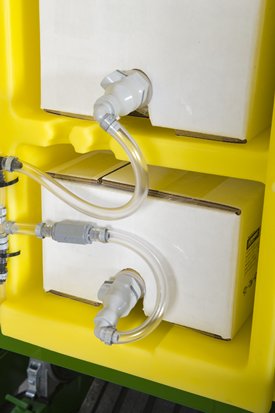 Connectors and in-line check valve
Connectors and in-line check valve
After the desired number of Force CS boxes are placed in the cabinet, the operator connects the Force CS box to the CIS system by using a connector (shown on the left). This connection device drastically reduces the amount of exposure compared to granular-type insecticide systems.
The system is also designed to empty the boxes from the top down. Product from the top boxes will empty before the system starts to pull product from the next row. This is possible by utilizing a check valve on the last product box (shown on the left).
Water tank
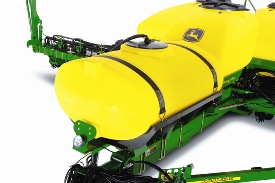 300-gal. tank on 1775NT 16Row
300-gal. tank on 1775NT 16Row
The CIS utilizes direct injection technology to move ounces of the Force CS product into water; therefore, every CIS requires an appropriately-sized water tank to supply the pump and valve assembly for Force CS application. Below is a chart with planter model, tank sizes, and acres covered.
Planter model |
Water capacity |
Acres/fill (water) |
Acres/fill (insecticide) eight-box cabinet |
Rate = 2 gal./acre |
Rate = 10 oz/acre |
||
30-ft 1795 |
852 L (225 gal.) |
46 ha (113 acres) |
104 ha (256 acres) |
40-ft 1795 |
1060 L (280 gal.) |
57 ha (140 acres) |
104 ha (256 acres) |
12-row 1775NT CCS |
852 L (225 gal.) |
46 ha (113 acres) |
104 ha (256 acres) |
16-row 1775NT CCS |
1136 L (300 gal.) |
61 ha (150 acres) |
104 ha (256 acres) |
24-row 1775NT CCS |
1703 L (450 gal.) |
91 ha (225 acres) |
104 ha (256 acres) |
DB60 |
1590 L (420 gal.) |
85 ha (210 acres) |
104 ha (256 acres) |
DB80 |
1590 L (420 gal.) |
85 ha (210 acres) |
104 ha (256 acres) |
DB90 |
1590 L (420 gal.) |
85 ha (210 acres) |
104 ha (256 acres) |
NOTE: Depending on model, water capacities may be reduced when equipped with Refuge Plus.
Pump and valve assembly
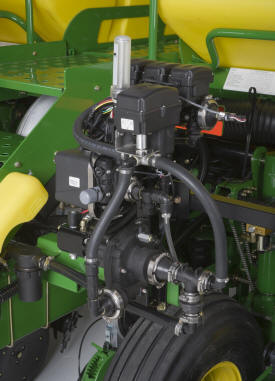 Pump and valve assembly
Pump and valve assembly
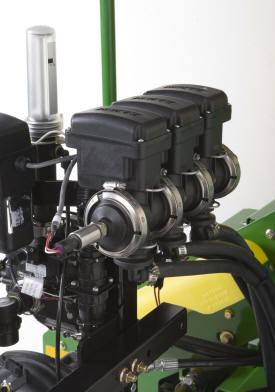 3-section valves
3-section valves
The pump and valve assembly consists of a hydraulically driven water pump, electric injection pump, and section valves. The hydraulic water pump is tied into the frame hydraulics and does not require an additional selective control valve (SCV). The electric injection pump pulls product out of the Force CS boxes and injects the product into the waterline, which then enters a mixing chamber where the water and Force CS are thoroughly mixed together.
The CIS system features a closed calibration procedure to protect the operator from insecticide exposure. Comparable granular type insecticide systems require the operator to collect chemical from each row unit on the planter, while the CIS closed calibration is performed at one central location and does not require the operator to measure any product, dramatically eliminating exposure to insecticide.
One of the many features of the CIS is the ability to apply insecticide on refuge rows only. From the tractor cab, the operator can set the monitor to apply insecticide to refuge rows only. This makes the CIS a perfect fit with Refuge Plus. When refuge only is selected on the monitor, the CIS will only apply insecticide on the designated refuge rows. These rows are predetermined from the factory and are listed below for each model.
| Model | Refuge rows |
1775NT CCS - 12row |
10, 11, 12 |
| 1775NT CCS - 16row | 13, 14, 15, 16 |
| 1775NT CCS - 24row | 20, 21, 22, 23, 24 |
| 1795 - 12/23row | 19, 21, 23 |
| 1795 - 12/24row | 20, 22, 24 |
| 1795 - 16/31row | 25, 27, 29, 31 |
| 1795 - 16/32row | 26, 28, 30, 32 |
| DB 60 | 20, 21, 22, 23, 24 |
| DB 80 | 14, 15, 16, 17, 18, 19, 20 |
| DB 90 | 15, 16, 17, 18, 19, 20, 21, 22 |
While the ability to apply Force CS to refuge rows is a unique feature, CIS can easily distribute product to every row across the entire planter width. Application setup is simple and is completed through the system monitor/controller.
Flow monitors
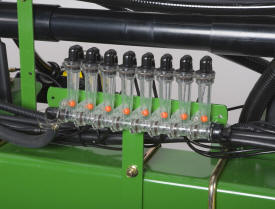 Flow monitors
Flow monitors
Flow monitors are mounted on the wings to provide operator confidence and peace of mind that each row is receiving an equal amount of product. When operating, the orange balls within the flow monitors will be suspended in the middle of the site glass. If a nozzle or delivery line becomes restricted or becomes damaged, the flow monitor will indicate this under or over application.
Nozzles
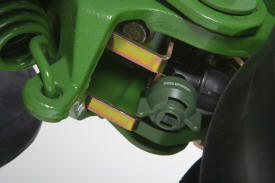 Nozzle
Nozzle
The CIS system utilizes a 0067 SprayMasterTM nozzle to apply the Force CS in 13- to 20-cm (5- to 8-in.) T-band over the seed furrow. This nozzle is located between the double disk openers and the closing wheels. When not in use, a nozzle cap is provided to replace the nozzle protecting it from wear.
Applying Force CS in a T-band pattern is the only approved application method. Spraying the product in a T-band ensures proper application and seed/soil coverage. The supplied 0067 SprayMaster nozzle is not compatible with any length of aftermarket seed firmer due to spray interference. If the planter is equipped with short seed firmer, a separate flat fan nozzle and adapter should be used.
Monitor
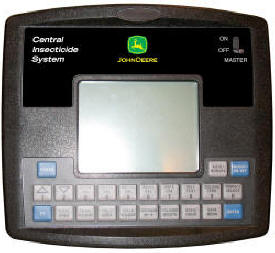 CIS monitor
CIS monitor
CIS utilizes a separate, independent monitor that also acts as the system controller. The monitor is capable of controlling two separate products at the same time (water and Force CS) and is compatible with GreenStar™ (GS) 2 Field Doc™ connect. This monitor is specific to the CIS and will not work with any other applications.
The monitor conveniently displays product application rates, acre totals, and product/acres remaining. System setup, product and water rates, as well as priming are initiated from the controller/monitor. CIS is completely integrated with the planter design. CIS automatically shuts off product flow when the planter is raised and is also tied to the seed meter one-half or one-third width disconnect.
System cleanout
CIS end-of-season cleanout and winterization is simple to perform. CIS will draw John Deere winterizer fluid (part N305643 or equivalent) through the system and residual Force CS with winterizing fluid solution will be captured in an enclosed container for proper disposal. Follow all label instructions for proper handling and disposal procedures.
IMPORTANT: Always read and follow label directions before buying or using this product. Force CS is a restricted-use pesticide.
Force® CS is a trademark of a Syngenta Group Company.
SeedStar™ XP monitoring system
SeedStar XP overview
 SeedStar XP shown on the GreenStar 3 2630 Display
SeedStar XP shown on the GreenStar 3 2630 Display
 SeedStar XP shown on the GreenStar 2 1800 Display
SeedStar XP shown on the GreenStar 2 1800 Display
Building upon the foundation of SeedStar 2, the SeedStar XP system takes planter monitoring to the next level. When paired with the GreenStar™ (GS) displays (GS 2600 or 2630 Display or the entry-level GS2 1800 Display), the SeedStar XP monitoring system provides more information about the planting process to the operator within the tractor cab.
Specific information about how the planter is performing enables the operator to make needed adjustments for implement optimization.
The SeedStar XP planting functions are fully integrated with the full spectrum of AMS applications such as Swath Control Pro™ system for planters, GreenStar AutoTrac™ assisted steering system, John Deere Operations Center, documentation, and others. Integrated planting technologies, for better asset utilization and ease of use, is just part of what SeedStar XP provides.
SeedStar XP seed singulation monitoring
 SeedStar XP seed singulation planter run page
SeedStar XP seed singulation planter run page
Understanding the meter singulation performance on the planter is critical to minimizing the amount of seed multiples and skips. As a result, the SeedStar XP monitoring system provides real-time information from the row-units about the overall seed singulation performance.
As seen in the screen shot image above, seed multiple information is displayed on the top portion of the planter-at-a-glance bar with seed skip information on the lower portion. This provides the operator a better understanding of relative seed multiple and skip data on a row-unit basis; all within one easy glance.
Also, within the seed singulation planter run page, information about row-units with the highest percentage of seed multiples and skips is provided in order to make necessary adjustments for better planter optimization.
SeedStar XP row-unit ride dynamics planter run page
 SeedStar XP ride dynamics planter run page
SeedStar XP ride dynamics planter run page
While operating a planter, travel speed and field conditions can affect the amount of row-unit bounce that is experienced. Excessive row-unit bounce or vertical motion can cause problems with meter performance. To better understand the amount of row-unit vertical motion when travelling through a field, the SeedStar XP monitoring system provides real-time information on row-unit ride dynamics.
As seen in the ride dynamics planter-at-a-glance screen shot image above, the SeedStar XP system provides ride dynamic information for each sensor node that is mounted on the planter. Each sensor node transmits ride dynamic information for each planter frame section to allow for the operator to make necessary operating adjustments to improve overall planting performance.
SeedStar XP row-unit downforce planter run page
 SeedStar XP downforce planter run page
SeedStar XP downforce planter run page
As row-unit downforce systems gradually change from heavy-duty downforce springs to pneumatic downforce, being able to understand the amount of as-applied row-unit downforce is needed while operating the planter.
With various soil conditions, moisture, etc. experienced while planting, it is imperative to have the ability to change actual row-unit downforce to have enough force for the Tru-Vee™ openers to penetrate the soil media. However, in some conditions, having too much downforce applied to the row-units for effective opener penetration could cause problems with side wall compaction from the gauge wheel.
Side wall compaction within the seed furrow can cause hatchet roots to develop; or roots that do not have the ability to penetrate the seed furrow soil media. This could lead to poor plant emergence and eventually lower overall yield performance.
With the SeedStar XP monitoring system, row-unit downforce information is measured by the downforce sensor and sensor nodes and transmitted to the GreenStar 2 (GS2) Display in the tractor cab (as seen in the image above). The row-unit downforce information is displayed on the top portion of the planter-at-a-glance bar with more row-unit downforce information on the lower portion.
Two different control options are available on 1775NT, 1795, and DB Series Planters for pneumatic downforce. The base pneumatic downforce system requires manual control of the downforce to maintain the desired planting results or row-unit margin. Optional active pneumatic downforce takes SeedStar XP even further by removing constant downforce adjustments from the operator and actively controlling the downforce system to maintain a desired target margin.
SeedStar XP seed spacing monitoring
 SeedStar XP seed spacing planter run page
SeedStar XP seed spacing planter run page
Throughout the planting process, obtaining good seed spacing is critical toward achieving plant growing conditions for maximum yield potential.
Today, many items are adjusted on the planter prior to planting to optimize overall seed spacing performance. After such adjustments are made, information about the actual seed spacing performance during planting was missing within the planter monitoring system. Now with SeedStar XP, seed spacing information is transmitted live via the GreenStar display to show the operator exactly what is happening with the planter behind them.
The SeedStar XP transmits seed spacing information onto the planter-at-a-glance bar for easy understanding of planter seed spacing performance. Also, information about seed skips and multiples is provided to help understand actual planter meter performance and other related system functions in order to make necessary adjustments if needed.
NOTE: Seed spacing and seed singulation information is only available when planting crops with seed drop rates below 40 seeds/second such as corn. With higher population crops such as soybeans the system does not provide spacing and singulation information because the number of seeds dropping per second is much higher.
SeedStar XP full planter performance page
 SeedStar XP planter details
SeedStar XP planter details
With the capability of monitoring differences in planting performance items such as seed singulation and row-unit downforce, having one screen to view all planter performance elements is needed to understand the whole planting system. SeedStar XP combines all of the various planting performance elements into one full-color, planter overview screen to enable for a quick understanding of relative planting functionality.
SeedStar XP half screens and other features
 SeedStar XP seed singulation half screen
SeedStar XP seed singulation half screen
 SeedStar XP seed spacing half screen
SeedStar XP seed spacing half screen
Other SeedStar XP monitoring features include:
- Capable of monitoring individual row-unit and overall planter performance in terms of seed spacing, singulation, and row-unit downforce
- Split-screen applications to enable use of popular guidance features such as AutoTrac™ assisted steering system
- On-screen indication of sensor node/downforce sensor assemblies once configured within the monitor settings application
- Full-color display icons for easy recognition and overall aesthetics
- Pneumatic downforce system controls with the GS Display application
SeedStar 2 monitoring original features
SeedStar XP retains all of those SeedStar 2 features that producers value and have come to expect:
-
Planter-at-a-glance. Allows operator to view relative population levels of all rows on one screen.
-
Automatic valve calibration. With the SeedStar variable rate drive (VRD), this is now completed automatically. There is no longer a need to manually calibrate the hydraulic valves.
-
Increased population updates. SeedStar will now update population levels once per second at planter start up then approximately once every three seconds.
-
Mapping of actual seed rates. When combined with documentation, actual and target seeding rates can now be mapped in John Deere Operations Center.
-
Reprogrammable utilizing controller area network (CAN) via Service ADVISOR™ diagnostics system.
-
Improved diagnostics/event recorder. On SeedStar variable-rate drive (VRD) planters, additional diagnostic information is available, as well as an event recorder to capture system performance data at a specific point in time.
-
Ability to run motors at different population levels. On SeedStar VRD, operators running multiple motor systems can run each motor at a different speed, allowing different population levels within a planter.
-
User-configurable high fertilizer pressure alarm. Allows the operator to be warned when fertilizer pressure reaches a specific level.
-
Automatic quick-start for SeedStar VRD. No longer does the operator need to press the quick-start button on end row turns to resume planting.
-
Automatic tractor speed source selection. When equipped with an 8000/9000 Series Tractor, the system selects the radar speed or allows for manual speed input selection.
Components and operation
 Planter main 2 controller
Planter main 2 controller
 Sensor node assembly installed
Sensor node assembly installed
The SeedStar XP monitoring system contains the following components in order to support the planting data transfer to the GS2 Displays:
- Seed monitor/variable-rate (SMVR) controller with model year 2011 or newer software
- Planter main 2 controller (installed on all SeedStar XP eligible models for model year 2011 or newer)
- Sensor node(s)
- Downforce sensor assembly
The planter main 2 controller processes the row-unit data from the sensor node assemblies located on the row-unit head casting. The processed information is then sent to the SMVR controller to be integrated into the displayed information being sent to the GS Display.
Downforce sensor assemblies are found on row-units with sensor nodes installed. The downforce sensor assembly is assembled with the gauge wheel depth-adjustment handle and provides gauge wheel pressure information to the respective sensor node for data processing.
 Downforce sensor installed
Downforce sensor installed
 Downforce sensor assembly
Downforce sensor assembly
Depending on the planter size, different configurations of sensor nodes and downforce sensors are installed in support of the SeedStar XP monitoring system.
Curve compensation

Most operators are not able to plant in perfectly square fields. Whether it is terraces or waterways, there are many field obstacles that make planting with curves impossible to avoid. When planters utilize drive shafts, they are not able to control each individual row-unit; as a result, planting on a curve presents an issue of maintaining 100 percent population. Since the inside rows are moving slower than the outside rows, the inside rows will be over populating while the outside rows are under populating.
With ExactEmerge and the curve compensation feature, each row will receive an individual signal based on the speed the row-unit is moving, maintaining the correct population across the length of the planter. Without curve compensation, there could be as much as a 24 percent drop in population accuracy, which is equivalent to 8,600 seeds per acre when planting at 36,000 seeds per acre. Curve compensation utilizes additional sensors on the planter and updated software to make precise changes to each row-unit to accurately maintain desired populations.
Easy Adjust row cleaners
 Coulter
Coulter
 Easy Adjust row cleaner
Easy Adjust row cleaner
Easy Adjust row cleaner and coulter combo provides a pneumatic row tillage solution that is controlled from the seat of the tractor.
Every decision to make an adjustment during spring planting reduces the acres planted per day and can increase or decrease profitability. An adjustment that can be overlooked is row cleaners due to planter size, difficulty to make the adjustment, varying conditions across fields and time.
 GreenStar™ 3 2630 Display view for Row Cleaners
GreenStar™ 3 2630 Display view for Row Cleaners
With the Easy Adjust row cleaners on ExactEmerge™ planters, operators now have a pneumatic solution to make on-the-go adjustments that is controlled directly from the seat of the cab. They can be raised from the cab as needed with the push of a button for wet areas, waterways, or end rows. The row cleaners are completely integrated into the John Deere GreenStar 2630 Display as well as the Gen 4 CommandCenter™ display with premium activation and do not require any additional monitors in the cab.
The Easy Adjust row cleaners have the capability to save three presets for varying ground engagement based on field conditions. The system is controlled in three sections, each wing as well as the center (frame or wheel) track rows. The pneumatic lines use air from the active pneumatic downforce compressor requiring no additional compressor to be installed on the planter. The Easy Adjust row cleaners utilize down and up force air bags. The adjustable air pressure setting for each bag allows the operator to set the ride of the row cleaner depending on the field conditions and the desired results. Making these on-the-go adjustments from tractor cab increases productivity and performance during planting.
The row cleaner only option utilizes parallel linkage to provide the floating action growers require in their fields. Parallel linkage allows for the unit to float up and down in the situation of hills or hard objects. The cleaner and coulter combo does not have parallel linkage, however, the row cleaners have floating rings installed to help provide the same benefits.
The row cleaners utilize the field-proven SharkTooth® design. Row cleaners play a major role in maximizing yield toward uniform emergence, reducing row-unit bounce and maintaining proper depth. The easy-adjust row cleaners provide growers with quick and stress-free solutions to customizing the planter in variable field conditions. Easy Adjust row cleaners are available on ExactEmerge and MaxEmerge 5e equipped planters. The Easy Adjust row cleaners are not integrated into RowCommand™ feature.
SharkTooth is a trademark of Yetter Manufacturing Incorporated.
SeedStar™ 3 HP monitoring system
SeedStar 3 HP overview
 SeedStar 3 HP shown on the GreenStar™ 3 (GS3) 2630 Display
SeedStar 3 HP shown on the GreenStar™ 3 (GS3) 2630 Display

Building upon the foundation of previous SeedStar monitoring, the SeedStar 3 HP monitoring system takes planter monitoring to the next level. When paired with the GS3 2630 Display, the SeedStar 3 HP monitoring system provides critical information about the planting process to the operator within the tractor cab. SeedStar 3 HP is compatible with the GS3 2630 and the Gen 4 4600 CommandCenter™ display.
Detailed planter performance information allows the operator to make adjustments needed for planter optimization. After all, with rising costs, it is imperative to make sure that every seed is planted accurately and precisely within the seed furrow for maximum yield potential.
The SeedStar 3 HP planting functions are fully integrated with the full spectrum of AMS applications such as John Deere Section Control for Planters, GreenStar (GS), AutoTrac™ assisted steering system, Apex™ software, John Deere Operations Center, JDLink™ telematics system, and others. Integrated planting technologies, for better asset utilization and ease of use, is just part of what SeedStar 3 HP provides.
SeedStar 3 HP main run page
 SeedStar 3 HP main run page
SeedStar 3 HP main run page
SeedStar 3 HP has an updated main run page layout. With the use of tabs toward the top of the screen it is much easier to navigate through readings such as population, singulation, spacing, downforce, and ride quality. If for some reason an issue arises with a row-unit, the tab will turn red indicating there is an issue. The tab can be pushed and lead to what is causing the issue. Inside each tab, there will be a bar graph detailing information specific to that tab. The picture shows what a population bar graph looks like. This layout improves functionality and overall ease of use while planting.
SeedStar 3 HP seed singulation monitoring
 SeedStar 3 HP seed singulation planter run page
SeedStar 3 HP seed singulation planter run page
Understanding meter singulation performance on the planter is critical to minimizing the amount of seed multiples and skips. As a result, the SeedStar 3 HP monitoring system provides real-time information, from the redesigned seed sensors placed in each belt cartridge, about the overall seed singulation performance.
As seen in the screen shot image to the left, overall singulation performance is seen in the tab at the top of the screen. Seed skip and multiple sources of information are displayed below the bar graph of the run page. This provides the operator a better understanding of relative seed multiple and skip data on a row-unit basis within one easy glance at this run page.
Also, within the seed singulation planter run page, information about row units with the highest percentage of seed multiples and skips is provided in order to make necessary adjustments for better planter optimization.
SeedStar 3 HP row-unit down force planter run page
 SeedStar 3 HP downforce planter run page
SeedStar 3 HP downforce planter run page
With changing field conditions, it is important to monitor down force to ensure consistent seed placement. Seeds placed too shallow or too deep can impact emergence and affect yield.
With the SeedStar 3 HP monitoring system, row-unit downforce information is measured by the down force sensor and sensor nodes and transmitted to the GS Display in the tractor cab. The row-unit down force information is displayed on the top portion of this run page with more row-unit down force information on the lower portion.
Active pneumatic down force takes SeedStar 3 HP even further by removing constant down force adjustments from the operator and actively controlling the downforce system to maintain a desired target margin. Just set the row-unit target margin value and the active pneumatic downforce system works automatically to make sure the planter maintains this value-achieving precise soil penetration, and consistent planting depth, without sidewall soil compaction. This frees the operator from constantly making manual downforce adjustments as conditions change.
SeedStar 3 HP ride quality and ground contact run page
 SeedStar 3 HP ride quality and ground contact run page
SeedStar 3 HP ride quality and ground contact run page
The fifth tab from the left in SeedStar 3 HP is a shared tab between ground contact and ride quality. Operators may change between the two criteria based on their planter setups or personal preferences. Ground contact displays the percentage of time the row-units are engaging the ground, the load is measured via a sensor through the gauge wheels. Ground contact is recommended when using ExactEmerge row units to ensure the row-unit is maintaining proper depth at higher planting speeds.
SeedStar 3 HP seed spacing monitoring
 SeedStar 3 HP seed spacing planter run page
SeedStar 3 HP seed spacing planter run page
Throughout the planting process, obtaining good seed spacing is critical towards achieving plant growing conditions for maximum yield potential.
Today, many items are adjusted on the planter prior to planting to optimize overall seed spacing performance. But after such adjustments are made, information about the actual seed spacing performance during planting was missing within the planter monitoring system. Now with SeedStar 3 HP, seed spacing information is transmitted live via the GS Display to show the operator exactly what is happening with the planter behind them.
The SeedStar 3 HP transmits seed spacing information onto the bar graph (shown to the left) for easy understanding of planter seed spacing performance. Also, information about seed skips and multiples are provided to help understand actual planter meter performance and other related system functions in order to make necessary adjustments if needed.
SeedStar 3 HP meter runoff page
 SeedStar 3 HP runoff page
SeedStar 3 HP runoff page
On SeedStar 3 HP, the meter runoff page allows growers to test meters before going to the field. Growers can now test the meters without removing them and have confidence in your planter’s performance before going to the field. Many parameters are able to be viewed during this test such as: singulation, seed count, skips, multiples, coefficient of variation (cv), etc. This test assures that the meter is in healthy condition and ready to plant when conditions are appropriate.
Other SeedStar 3 HP monitoring features include:
- Capable of monitoring individual row-unit and overall planter performance in terms of seed spacing, singulation, and row-unit downforce
- On-screen indication of sensor node/down force sensor assemblies once configured within the monitor settings application
- Full-color display icons for easy recognition and overall aesthetics
- Pneumatic downforce system controls with the GS Display application
- The run page allows operator to view relative population levels of all rows on one screen
- Mapping of actual and target seed rates can be mapped in Apex
- Reprogrammable utilizing controller area network (CAN) via Service ADVISOR™ diagnostics system or Service ADVISOR Remote with JDLink™ subscription
- User-configurable high fertilizer pressure alarm. Allows the operator to be warned when fertilizer pressure reaches a specific level
- Automatic Fast Start for SeedStar 3 HP. This ensures that seeds will be place accurately when starting from a stop
- Automatic tractor speed source selection. When equipped with an 8000/9000 Series Tractor, the system selects the radar speed or allows for manual speed input selection
Components and operation
 Planter main controller
Planter main controller
 Row-unit controller (RUC) with two electric motors
Row-unit controller (RUC) with two electric motors
The SeedStar 3 HP monitoring system contains the following components in order to support the planting data transfer to the GS Displays:
- Planter main controller
- Sensor node(s)
- Downforce sensor assembly
- Electric power gen controller
- Electric power gen (EPG)
- Row-unit controller (RUC)
The row-unit controller processes the row-unit data from the sensor node assemblies located on the row-unit head casting. The processed information is then sent to the planter main controller to be integrated into the displayed information being sent to the GS Display.
Downforce sensor assemblies are found on row units with sensor nodes installed. The downforce sensor assembly is put together with the gauge wheel depth-adjustment handle and provides gauge wheel pressure information to the respective sensor node for data processing.


Depending on the planter size, different configurations of sensor nodes and downforce sensors are installed in support of the SeedStar 3 HP monitoring system.
SeedStar 3 HP is only available with the MaxEmerge 5e and ExactEmerge™ row-unit compatible planters.
MaxEmerge™ 5 row-unit
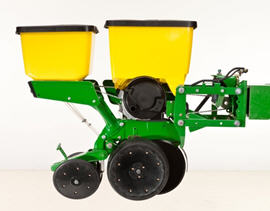 MaxEmerge 5 with 56-L (1.6-bu) hopper plus insecticide
MaxEmerge 5 with 56-L (1.6-bu) hopper plus insecticide
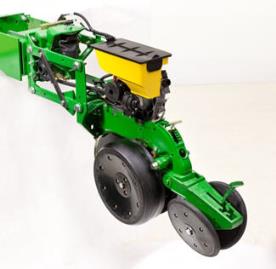 MaxEmerge 5 with mini hopper on CCS™ machines only
MaxEmerge 5 with mini hopper on CCS™ machines only
The MaxEmerge family of row-units have never seen a more versatile and efficient design until the MaxEmerge 5. The 5-family row-units improve productivity, increase uptime and lower the cost of ownership like never before.
The MaxEmerge 5 row-unit was designed for improved performance and serviceability.
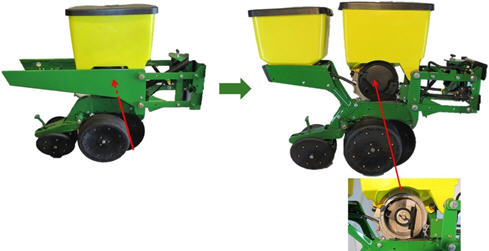

Serviceability and changing crops has always been a focus of downtime and potential seed loss. MaxEmerge XP row-units (shown on the left) are designed with the meter and hopper as one component. The frame covers the meter so that it cannot be accessed. Cleanout of excess seed requires the operator to take the entire hopper off of the row-unit and to turn it upside down. The MaxEmerge 5 meter (shown on the right) is accessible without having to remove the box. The MaxEmerge 5 design allows large hoppers to be cleaned out the same as mini-hoppers, simply by opening the meter dome and catching the seed as it falls out. This improvement allows operators to change seed varieties easier and three times faster than it took them on the previous MaxEmerge XP units and provides more uptime during the tight planting window.
 MaxEmerge™ 5 vacuum seed meter
MaxEmerge™ 5 vacuum seed meter
The vacuum meter system gently pulls and holds individual seeds to the holes of the seed disk for population control and spacing accuracy, equaling better crop stands and profit. Vacuum seed meters can plant a wide variety of crops and seed types by simply changing seed disks and adjusting vacuum level. Vacuum seed meters are available for planters with MaxEmerge 5 row-units.
Additional features of the vacuum seed meter include:
- One moving component (the seed metering disk) for minimum maintenance requirements
- Meter located at each row-unit for accurate seed delivery
- Good hopper seed flow characteristics for longer operating time per hopper fill
- Low airflow in meter so seed treatments are not removed
 Pro-Series™ seed pool
Pro-Series™ seed pool
 MaxEmerge 5 seed pool
MaxEmerge 5 seed pool
The MaxEmerge 5 meter shape has also been redesigned for better seed flow. The mini-hopper design allows the planter to successfully operate on side hills up to 14 degrees.
Vacuum meter hub and latching handle
 MaxEmerge 5 vacuum meter with disk
MaxEmerge 5 vacuum meter with disk
Both the MaxEmerge 5 vacuum meters are equipped with a heavy-duty hub spring and disk latching handle. The spring ensures the seed disk stays properly positioned when operating flat-style seed disks and higher vacuum levels. Proper seed disk positioning means repeatable seed singulation, time after time. The disk-latching handle is designed for easy operation and effortless seed disk changeover. The hub is also machined to tight tolerances to further ensure alignment of metering components.
Operating characteristics of vacuum seed meter
 Operating speed with seed tube technology
Operating speed with seed tube technology
The vacuum seed meter is capable of operating at faster planting speeds than mechanical meters. However, planting accuracy will be influenced by seedbed conditions and the operating characteristics of the seed meter. Rough seedbeds and fast planting speeds (above 8.9 km/h [5.5 mph]) typically deteriorate seed placement accuracies when using seed tube technology.
The chart illustrates the effect operating speed has on population when using the vacuum meter. The operating band (color area) illustrates how the vacuum meter performs in relation to the desired population (indicated by horizontal line). The width of the band is due to various sizes and shapes of seeds and planting rate variations.
When operating on slopes above 15 degrees, increased or decreased population may result. To minimize this effect, reduce speed and consider using a flat style seed disk with increased vacuum level.
Vacuum meter seed disks
The ProMAX 40 Flat Disk: The flat-disk planting solution field-proven to work since 1991

The design of the ProMAX 40 Flat Disk position allows seed to be released from the optimum position above the seed tube. The flush-face seed tube allows the seed to drop uninterrupted through the tube.
The ProMAX 40 Flat Disk utilizes flat holes and a higher vacuum level to ensure every hole is populated with a seed. A double eliminator gently removes multiple seeds at each hole for precise population control. A knockout wheel makes certain that each hole is clear of any debris after the seed is released from the disk.
 Flat-style and cell seed disks shown
Flat-style and cell seed disks shown
The unique cell disk design allows planting a variety of seed sizes without any additional parts or individual meter adjustments. Another advantage of cell-type seed disks is the lower vacuum requirement compared to flat-style seed disks. Lower vacuum levels mean less hydraulic demand from the tractor. Most planting conditions call for a flat disk, if you are limited in hydraulic capacity, cell disks are recommended.
Double eliminator

For difficult to singulate seeds, a flat seed disk and double eliminator is a viable alternative to traditional cell-type seed disks. By design, a flat seed disk requires higher levels of vacuum than a cell-type disk because there is no pocket or cell to hold the seed. The higher vacuum level will pull more than one seed to the holes in the seed disk. The double eliminator is set to cover a portion of the hole in the seed disk and is the mechanism to knock multiple seeds away as the disk rotates.
Double eliminators are required with flat-type seed disks only and should not be used with cell-type seed disks. The knockout wheel is also recommended in conjunction with the double eliminator and flat seed disk to ensure seed is ejected from the disk.
Flat and celled type seed metering disks are available to allow planting a wide variety of seed types.
- Corn (field, popcorn or sweet corn)
- Soybeans
- Cotton
- Sorghum
- Sugar beets
- Sunflowers
- Edible beans/peas
- Peanuts
- Melons, squash, cucumbers
Mini-hopper row-units, which are used only with the Central Commodity System (CCS™) are compatible only with crops that the CCS is approved to plant.
- Corn
- Popcorn
- Sweet corn
- Soybeans
- Sunflowers
- Sorghum
- Cotton
NOTE: Due to small seed size and low planting populations, sugar beets can be planted with mini-hopper style meters by adding hopper extensions and not using the CCS tank. These hopper extensions can also be used for planting test plots.
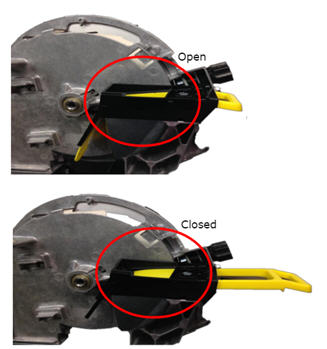 Hopper shutoff
Hopper shutoff

Also, to help with meter access of 56-L and 106-L (1.6-bu and 3-bu) hoppers the hopper shutoff feature was added. With the shutoff engaged, the meter cover can be opened without first having to remove all of the seeds from the hopper. Lever down, the seed flow is on, lever horizontal and the seed flow is off.
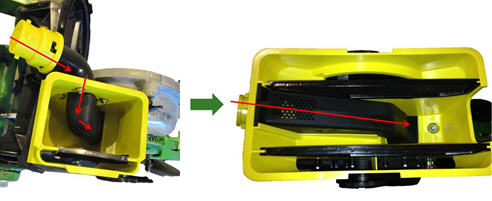 MaxEmerge 5 mini-hopper
MaxEmerge 5 mini-hopper

There are significant changes to the MaxEmerge 5 Mini-Hopper. One update is the straight feed from the Central Commodity System (CCS™) hose to the mini-hopper to ensure a continuous free flow of seeds. This design change reduces the potential for plugging issues with larger seed size and the use of seed treatments. By drawing air from the CCS tank the vacuum source is now cleaner, preventing meter debris buildup.
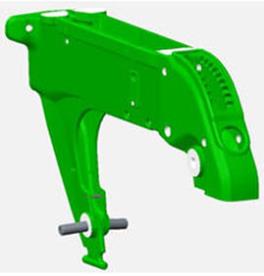 Ductile iron-cast shank
Ductile iron-cast shank

Ductile iron casting is a unique high-tech process that produces a single-piece row-unit shank this enables alignment from the seed trench to the closing wheel.
The row-unit head is also designed using the ductile iron-casting process. The row-unit head provides the mating joints between the row-unit parallel arms and the row-unit shank. It is also the upper attaching point for the seed meter and seed hopper.
Ductile iron casting of the row-unit shank and head assembly provides a row-unit that is 25 percent stronger than other competitive welded row-units.
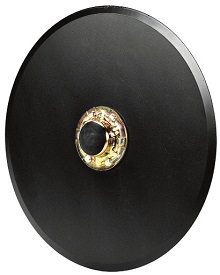
One of the trademark capabilities of John Deere planters has always been the ability of the Tru-Vee™ openers to provide an ideal seed furrow.
The thickness of the Tru-Vee opener blade is 3.5 mm (0.14 in.) this blade thickness will provide extended wear life.
The MaxEmerge 5 row-unit also provides better Tru-Vee opener bearings for longer life. The double-row ball bearing provides up to three times the wear life as the single-row bearing.
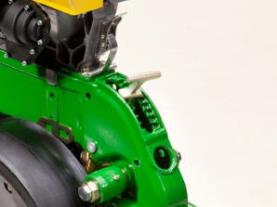 Depth adjustment T-handle
Depth adjustment T-handle

John Deere planters provide consistent seed depth control in all field conditions. Depth control is a function of the Tru-Vee openers, the downforce system, and the gauge wheel assembly.
The gauge wheel itself is made of durable nylon composition with a concave profile. This profile gently firms the sides of the seed furrow, ensuring a well-defined trench. The shape reduces rocks and residue being picked up and thrown onto the drive chains and row-units, and helps to prevent rooster tailing of soil.
The bolt-through design utilizes an open bearing in the gauge wheel that allows an attaching bolt to pass through the wheel to the threaded hole in the gauge wheel arm. This simple bolt-through design provides for a positive attachment of the gauge wheel to the gauge wheel arm and allows quick removal of the gauge wheel for service.
Adjustability of the row-unit is critical to good performance. More available downforce options than any row unit in the industry
- Adjustable heavy-duty downforce, four settings, 0 kg (0 lb), 57 kg (125 lb), 113 kg (250 lb), and 181 kg (400 lb) of downforce
- Pneumatic downforce, infinitely variable from 0 to 181 kg (0 to 400 lb) of downforce
- Active pneumatic downforce adjusts automatically for changing ground conditions from 0 to 181 kg (0 to 400 lb) of downforce
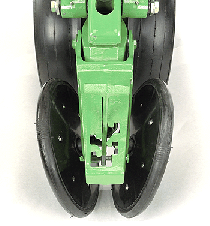 Rubber tire closing system
Rubber tire closing system
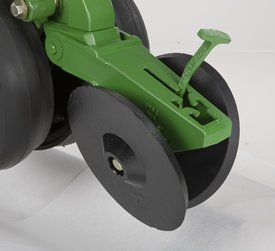 Cast wheel closing system
Cast wheel closing system
Rubber tire closing systems are used for most conventional, minimum-till, and no-till planting conditions. The spacing between the wheels is adjustable so the closing system can meet the needs of those who want to plant small seeds at shallow depths.
The wheels can also be staggered fore and aft to enhance residue flow. Four levels of spring force are available and are easily set with the integrated T-handle adjustment. A lower force spring can be obtained from parts, if a lower amount of force is required.
Additional closing wheel options include:
- Cast closing wheels, for tough-to-close conditions
- Disk closing, for shallow planting depths
- Closing wheel frame less wheels, for growers desiring to use aftermarket closing wheels
Downforce system options

Heavy-duty adjustable downforce springs
 Heavy-duty adjustable downforce spring
Heavy-duty adjustable downforce spring
Planter row-unit downforce is an important factor to ensure consistent and proper depth control. The heavy-duty adjustable downforce feature provides up to 400 lb of downforce. There are four settings available to allow the user to choose the amount of downforce required for the condition: 0 lb, 125 lb, 250 lb, and 400 lb.
Compatibility: 1705, 1715, 1725, 1735, 1755, 1765, 1765NT, 1775 Flex, and 1785
Standard pneumatic downforce system
Pneumatic downforce provides convenient, simple adjustment of downforce for the whole planter from one location. The amount of downforce applied is infinitely adjustable from 0 to 181.80 kg (0 to 400 lb). Pneumatic downforce provides more consistent downforce throughout the range of row-unit travel than mechanical spring downforce systems.
Features include:
- 9.5-mm (3/8-in.) air delivery line instead of the 6.4-mm (1/4-in.) line used on model year 2010 and older planters.
- Air compressor assembly increased duty cycle. With this compressor, it provides a 47 percent increase in maximum air flow delivery compared to the prior air compressor.
- Pneumatic air bags with 9.5-mm (3/8-in.) air line inlets that have greater durability.
 Pneumatic downforce spring
Pneumatic downforce spring
Each row-unit has a single rubber air bag located between the parallel arms. The air bags are hooked in parallel so that air can be added or released from all rows at once from one location.
The individual pneumatic downforce air bag assemblies, air compressor units, and 9.5-mm (3/8-in.) delivery lines are also available as an attachment for field conversion.
 Pneumatic downforce compressor and gauge
Pneumatic downforce compressor and gauge
An improved compressor is used to charge the pneumatic system. This compressor can be located on the planter frame or in the tractor cab if desired. A gauge at the compressor indicates the amount of downforce being applied.
From the factory, integral planter models with pneumatic downforce will have an improved air compressor assembly with an in-cab mounting bracket, except the 1725 16-row and 1725 Central Commodity System (CCS™ ) twin row planters will have the air compressor assembly mounted on the planter frame. For drawn planter models, the 1755, 1765, 1765NT, 1775 Front-Fold, and 1785 Drawn Planters will have the air compressor assembly installed either on the outer hitch or wing frame members when the pneumatic downforce system is installed.
Base equipment on: 1705, 1715, 1725, 1735, 1755, 1765, 1765NT, 1775 and 1785.
Integrated pneumatic downforce system
The functional features of the integrated system are the same as the standard pneumatic system, explained above, with the addition of control through the GreenStar™ display.
System control with GreenStar™ (GS) display
 Pneumatic downforce control in GS2 display
Pneumatic downforce control in GS2 display
 Air compressor mounted on 1775NT outer hitch
Air compressor mounted on 1775NT outer hitch
On 1725 16-row, 1725 Central Commodity System (CCS™) TR, 1775NT, 1775NT CCS, 1795, DR, and DB Series Planter models, the air compressor will be mounted on the outer hitch or frame assembly. Since the air compressor assembly is mounted on the outer hitch (as noted in the picture above) or frame, adjustments for row-unit downforce and related system pressures will be made electronically with the GS Display.
When adjusting the amount of row-unit downforce using the GS Display, the operator will select the amount of downforce (lb) to be applied across the planter. Depending on the soil conditions at hand, the operator might need to adjust the relative amount of row-unit downforce being applied during the planting operation. The integrated pneumatic downforce controls within the GS Display will only allow for set-point operation and not automatic control as the planter is operating in different soil conditions. The pneumatic downforce system does not have the capability to automatically adjust downforce.
On-board air storage
 Onboard air storage installed on 1775NT 24R30
Onboard air storage installed on 1775NT 24R30
The 1725 16-row, 1725 CCS TR, 1775NT, 1775NT CCS, 1795, DR, and DB Series planters will have onboard air storage to increase the overall response time when making a row-unit down force adjustment from the GS Display. The onboard air storage is comprised of a 19-L (5-gal.) storage tank with valve assembly.
Base equipment on: 1725 CCS, 1725 16-row, 1725T, 1775NT, 1775NT CCS, 1795, DR, and DB Series Planters with MaxEmerge™ 5 row units. MaxEmerge 5e and ExactEmerge™ equipped planters come with active pneumatic downforce in base.
Active pneumatic downforce
 Active downforce compressor assembly
Active downforce compressor assembly
 Hydraulic motor
Hydraulic motor
A hydraulically driven compressor works with the SeedStar™ 3 HP system and SeedStar XP system to automate downforce control. Just set the row-unit target margin value and the active pneumatic downforce system works automatically. The system will make sure the planter maintains this value, achieving precise soil penetration, and consistent planting depth, without sidewall soil compaction. From the factory the system is set at 100 lb target downforce margin, but may be modified for varying field conditions. This frees the operator from constantly making manual downforce adjustments as conditions change.
This system offers a split rank control feature for 1795 and DB Split-Row Planters. On split row planters active downforce will control the front and rear rows independently. This compensates for differing downforce requirements between the ranks that can be caused from things like different tillage or insecticide attachments and will help maintain an accurate planting depth and consistent margin across all the rows.
Active pneumatic downforce is available as factory installed or as an attachment for field conversion.
SeedStar XP row-unit downforce planter run page
 SeedStar XP downforce planter run page
SeedStar XP downforce planter run page
Active downforce control is integrated into SeedStar XP and SeedStar 3HP monitoring systems.
Margin is the amount of weight riding on the depth gauge wheels that ensures desired firming of the seedbed as set by the operator.
Once a target margin has been defined, enter the value into SeedStar XP or SeedStar 3HP and let active downforce do the rest. The system will actively adjust the air pressure in the air bags to maintain a constant margin across the planter. The changes in air pressure will change the amount of downforce placed on the row unit compensating and reacting for varying conditions through the field whether it is different tillage practices, soil types, or moisture.
 Down force and margin example
Down force and margin example
A) Margin – Amount of additional down force applied to a row unit above and beyond what is required for penetration to achieve planting depth. This additional weight will ride on the depth gauge wheels. 120 + 80 = (200 – 150) = 23 kg (50 lb) of margin
B) Weight of row-unit - 54 kg (120 lbs)
C) Downforce – Force that is applied to the row-unit by the air bag circuit - 36 kg (80 lb)
D) Resistance from soil - 68 kg (150 lb)
Hydraulically driven compressor
 Hydraulic motor
Hydraulic motor
 Pneumatic valve
Pneumatic valve
The hydraulically driven air compressor can deliver up to eight times the air flow allowing for more and faster downforce changes to be made. This more robust design features a 38-L (10-gal.) storage tank across all models with active downforce.
At approximately 4 gpm, hydraulic demands are low and ties into the machine’s lift and Central Commodity System (CCS™) hydraulic circuit so it does not require any additional selective control valves (SCVs). The SeedStar XP and SeedStar 3HP monitoring systems work with the compressor and valve assembly to regulate air to downforce springs enabling the active control.
Another feature of John Deere active downforce is the ability for the pneumatic valve to independently control split rank machines. This system senses the downforce needs from the front and rear ranks separately and independently adjust air pressures with the dual rank pneumatic valve when equipped. Active pneumatic downforce requires SeedStar XP or SeedStar 3HP to enable active control.
Base equipment on: All MaxEmerge™ 5e and ExactEmerge™ equipped planter models.
Individual row hydraulic downforce (IRHD)

IRHD has been specifically designed to meet the needs of producers that are looking to adjust to the toughest field conditions and provide maximum yield potential from field to field, season after season. IRHD works as a closed-loop downforce system that reacts quickly on an individual row basis to changing soil conditions supporting increased ground contact, which can lead to improved seed depth consistency. When setting planter downforce margin the system will apply the needed downforce by row to maintain ground contact. From the factory the margin will be set at 100 lb, changes may be required based on varying field conditions.
The system allows growers to maintain gauge wheel ground contact leading to desired seed depth placement. IRHD can adjust five times per second and make adjustments of 45.4 kg (100 lb) in less than a second. The system has a total range of applied downforce from 50 lb to 450 lb and utilizes the power beyond circuit on the tractor. IRHD is 58 percent faster than active pneumatic downforce solution. Fast reaction and increased ground contact can lead to improved emergence. With uniform emergence some studies have shown a yield impact from 5% to 9%.
Optional equipment on: 1775NT, 1795 and DB models with MaxEmerge™ 5e and ExactEmerge™ row units.
DB60 24R30 frame
Three-section, front-fold toolbar
 DB planter
DB planter

The DB60 24R30 Central Commodity System (CCS™) with Pro-Series XP™ row-unit planters feature the Bauer Built Mfg. frame that offers increased strength through the use of 7-in. x 7-in. steel. Not only rugged, both of these well-designed frames offer a clean look, with neatly routed hoses and cables for easy servicing.
The DB60 Planter frame has superior frame flexibility for even-depth planting when working rolling ground. The three-section frames allow each wing to flex 15 degrees up and down relative to the planter's center section.
The DB60 24R30 features 6 row-units on the center frame section and 9 row-units on each wing.
Transport
 DB in transport
DB in transport

The DB60 24R30 Planter equipped with Pro-Series XP row-units folds to a transport width of 15 ft and a length of 41 ft.
The combination of narrower transport widths, low center of gravity, and more ground clearance make the DB60 a very stable planter in transport.
Frame tires
 DB main frame tires
DB main frame tires
 DB optional mainframe tires
DB optional mainframe tires
Four large 16.5 x 16.1 main frame tires and four 31-13.5x15 wing tires keep the DB60 floating on top of the ground, while wheel spacing improves residue flow. Each wing also utilizes a walking tandem for even planting and excellent float across unlevel fields. The DB60 can be equipped with larger 445/50R22.5 mainframe tires as an option.
RowCommand™ individual-row control system
RowCommand controls seed output
 RowCommand on a MaxEmerge™ 5 row-unit
RowCommand on a MaxEmerge™ 5 row-unit
 RowCommand on a chain drive MaxEmerge 5 row-unit
RowCommand on a chain drive MaxEmerge 5 row-unit
Controlling input costs and improving productivity are key producer requirements today. RowCommand is an effective, integrated John Deere solution designed to meet these intensifying needs. The RowCommand system manages seed output, reduces yield drag, and improves harvest capabilities on all Pro-Shaft™ driven row-units, and chain-driven MaxEmerge 5.
NOTE: Chain-drive RowCommand is only compatible with planters equipped with pneumatic downforce systems. On planters equipped with the heavy-duty downforce springs, potential chain interference may result and is not recommended.
NOTE: Chain-drive RowCommand requires some modification to brackets in order to function with corn finger pickup meters.
NOTE: Pro-Shaft drive RowCommand is compatible on MaxEmerge 5 row-units with vacuum and corn finger pickup meters. For mini hopper row-units, RowCommand is compatible on vacuum meters only and is not compatible on corn finger pickup meters. Pro-Series XP row-units with corn finger pickup meters are not compatible with RowCommand.
RowCommand controls seed output by incorporating individual, low amperage clutches inside the Pro-Shaft and chain-driven gearboxes. Clutches are completely enclosed within the gearbox housing to protect them from the elements and harsh operating conditions.
When power is supplied, either manually or through John Deere Section Control software, clutches disengage the seed meters and seed flow stops. Controlling seed output at individual rows reduces overplanting in point rows and maximizes seed placement when entering/exiting headlands.
Components and operation
 EPMs shown on a 1775 NT Planter
EPMs shown on a 1775 NT Planter
 RowCommand clutch on MaxEmerge 5 with 3-bu hopper
RowCommand clutch on MaxEmerge 5 with 3-bu hopper
RowCommand is a simple and efficient solution to control individual row planting. This system does not utilize air to operate; therefore, no compressor, air lines, or valve modules are required.
RowCommand utilizes low-voltage controller area network (CAN) messaging to signal power to the desired clutches to stop planting or eliminates power to resume planting.
This means very little power is used in normal planting conditions, and in the event a clutch fails electrically, the meter will continue to plant.
The RowCommand system requires the following five basic components to operate:
-
Electric clutches
-
Electronic power modules (EPMs)
-
SeedStar™ 2 monitoring (wedge box/controller)
-
GreenStar™ (GS) display
-
Planter wiring harnesses
Clutches are protected within the sealed Pro-Shaft and chain-driven gearboxes for years of trouble-free operation and simple installation or removal. RowCommand has true individual-row control of up to 16 clutches or sections for planters larger than 16 rows.
Unique to RowCommand, the 16 available control sections can be configured based on operator preferences. For example, on a 1775 NT 24-Row Planter, every two rows can be paired together for a total of 12 control sections, or control the outermost eight rows individually and the remaining inner rows paired together for 16 control sections.
While SeedStar with RowCommand has 16 control sections, a minimum of 152-cm (60-in.) wide sections are recommended for optimum Swath Control Pro™ solution capabilities. As with other Swath Control Pro products, a SF 2 signal is the minimum level of accuracy recommend for operation.
Pro-Shaft drive RowCommand planters
RowCommand is available as a factory-installed option or as an attachment for field conversion attachments for the following Pro-Shaft drive planter models (see chart below).
| Planter model | Row configuration |
| 1725 | 12-row narrow, 12-row wide, and 16-row narrow |
| 1725 CCS™ | 16-row narrow |
| 1765 | 12-row narrow |
| 1775 | 12-row narrow |
| 1775NT | 12 row, 16 row, and 24-row narrow |
| 1775NT CCS | 12 row, 16 row, and 24-row narrow |
| 1795 | 12/23 row, 12/24 row, 16/31 row, and 16/32 row |
| 1795 | 24 row, 50 cm (20 in.) |
| DB 44 | 24 row, 56 cm (22 in.) |
| DB 58 | 32 row, 56 cm (22 in.) |
| DB 60 | 36 row, 50 cm (20 in.) or 47 row, 38 cm (15 in.) |
| DB 66 | 36 row, 56 cm (22 in.) |
| DB 80 | 32 row, 76 cm (30 in.) or 48 row, 50 cm (20 in.) |
| DB 88 | 48 row, 56 cm (22 in.) |
| DB 90 | 36 row, 76 cm (30 in.) |
| DB 120 | 48 row, 76 cm (30 in.) |
DR (Deere/Orthman™ planter) 16R40 |
16 row, 102 cm (40 in.) |
| DR (Deere/Orthman) 18R38 | 18 row, 97 cm (38 in.) |
Chain drive RowCommand planters
In terms of planter compatibility, RowCommand for chain drive is designed for the following planter model configurations equipped with pneumatic downforce systems.
| Planter model | Row configuration |
| 1725 | 12-row narrow, 12-row wide, and 16-row narrow |
| 1765 | 12-row narrow |
| 1775 | 12-row narrow |
| 1775NT | 12 row, 16 row, and 24-row narrow |
| 1775NT CCS | 12 row, 16 row, and 24-row narrow |
| DB 44 | 24 row, 56 cm (22 in.) |
Chain drive RowCommand and heavy-duty downforce
 Chain interference with heavy-duty downforce
Chain interference with heavy-duty downforce
As seen in the picture, chain interference may result when operating chain-drive RowCommand on planters equipped with short and long parallel arms and heavy-duty downforce springs.
NOTE: Chain-drive RowCommand is only compatible with planters equipped with pneumatic downforce systems. On planters equipped with the heavy-duty downforce springs, potential chain interference may result and is not recommended.
Chain-drive RowCommand with corn finger pickup meters
 Bracket material removal
Bracket material removal
Due to the design characteristics of the chain drive RowCommand clutch, some modification to the corn finger pickup meter drive bracket is required. As seen in the picture to the left, some material needs to be removed from the front of the meter drive bracket in order for the chain-drive RowCommand clutch to have sufficient space for installation.
NOTE: Chain drive RowCommand requires some modification to brackets in order to function with corn finger pickup meters.
RowCommand ordering information
To add RowCommand to a model year 2009 and newer planter model listed above is simple. Pro-Shaft drive attachments for field conversion and chain drive attachments for field conversion are available by planter model to add the appropriate number of clutches, EPMs, brackets, hardware and row-unit harnesses. For complete installation and part detail for the RowCommand conversion, please use the RowCommand compatibility tool per specific planter model.
RowCommand is compatible and available for model year 2003 (serial number 700101) to 2008 (725101) planter models listed above. In addition to the attachment for field conversion attachment, a planter mainframe harness, SeedStar 2 controller (wedge box), and additional CAN harnesses are needed.
Integrated Swath Control Pro
Coupling RowCommand with Swath Control Pro provides the ultimate in precision planting and productivity. One company, one integrated solution are what we offer by incorporating Swath Control Pro capabilities within the SeedStar 2 wedge box (controller). Unlike previous systems, no rate controller, additional harnessing, or components are required to achieve automated individual-row control.
SeedStar 2 monitoring, RowCommand, and Swath Control Pro activation from John Deere Precision Ag Technologies are all that is needed when ordering.
System requirements
RowCommand is a simple and efficient means to control individual row planting through the use of low-voltage electric clutches. When activated, each clutch consumes no more than 0.5 amps. By design, power is only supplied to the clutch when a signal is received to stop planting. In a normal planting condition, no power is supplied and the clutch is de-energized.
Power for the RowCommand system is provided from the 9-pin ISO implement connector. All late-model 8X00 and 9X00 Series John Deere Tractors equipped with the 9-pin ISO implement connector are capable of supplying ample power for system operation.
Along with ample system power, a GreenStar display and SeedStar monitoring are required for operation and control interface. The GreenStar display is where system setup, control settings, and manual control functions are performed.
Provide added versatility and productivity with Central Commodity System (CCS™) Refuge Plus™ planter configuration
 CCS Refuge Plus option shown on 1775NT
CCS Refuge Plus option shown on 1775NT
1775NT, 1795, and DB models with CCS can be equipped with the Refuge Plus option.
The third tank on the Refuge Plus system provides increased versatility and productivity to the planting operation by allowing the grower to plant two different varieties simultaneously. The Refuge Plus tank has manifold nozzles, or outlets, to supply seed to eight different row-units.
Refuge Plus is ideal for the corn grower planting Bt corn or seed corn. Refuge Plus is the solution for refuge management compliance issues associated with Bt corn production. The 880-L (25-bu) capacity of the third tank makes planting the required 20 percent refuge of non-Bt corn easier while maintaining high productivity levels of the central-fill CCS.
For example, the Bt corn planted on 80 percent of the field goes into the larger CCS tanks. The required 20 percent refuge, non-Bt corn, goes into the third Refuge Plus tank with the seed hoses routed to the desired rows.
Central fill with CCS is now easier for the seed-corn grower as well. The seed-corn grower can plant both male and female seed in the desired pattern simply by placing the male seed in the Refuge Plus tank, the female seed in the CCS tanks, and routing the seed delivery hoses to the desired row units.
Redirecting seed delivery
 Seed delivery hose connection and yellow plug
Seed delivery hose connection and yellow plug
Redirecting seed delivery from the CCS tanks to the Refuge Plus tank is a snap with quick- disconnect couplers. By simply disconnecting the desired CCS delivery hoses from beneath the CCS tank, capping those hoses and reconnecting the delivery lines to the Refuge Plus tank the seed delivery source is changed.
Due to the additional weight Refuge Plus places on the planter frame, liquid fertilizer tanks are not compatible. Updated liquid insecticide tank codes have been established for Refuge Plus Planters.
Seed variable rate drive (VRD) with half- or three-width disconnect
 VRD shown on a 1775NT
VRD shown on a 1775NT
The seed variable-rate drive provides the ultimate planting productivity by utilizing one, two or three hydraulic motors (varies by model) to turn the seeding drive shaft. Hydraulic control of the seeding drive allows for on-the-go seeding rate changes right from the display mounted inside the tractor cab.
Combine this seeding flexibility with the map-based planting option, and seeding rates adjust automatically based on a prescription map.
Single- or dual-motor systems for variable-rate drives are available for all John Deere planters except the 1785 Rigid Frame. Dual- or three-motor drive systems are commonly used on larger (12-row and more) planters and offer the capability of half-width or three-section drive disconnect.
The VRD is available as a factory-installed option for all applicable planter models. Single- or dual-motor systems are available as field-installed attachments for most planter models; however, a three-motor VRD field-installed attachment is not available.
The seed VRD requires the SeedStar™ monitor and a radar input signal. Either tractor or planter radar may be used. Planter radar is ordered separately.
VRD offers the following advantages over common, contact-tire drive systems:
-
Almost instantaneous rate changes; there is no ramp up or ramp down of system as in some competitive systems
- Permits the operator to match seed population based on different soil types or irrigation practices
- John Deere design that provides added operator safety by eliminating any possible drive creep found in some competitive variable rate drive systems
Half-width drive disconnect
The half-width drive disconnect feature is excellent for the producer concerned with controlling seed costs. This feature helps the operator place seed in the desired area and limit the amount of costly overlapped planting.
The half-width drive disconnect allows the operator to turn off half of the planter at a time for planting end rows, point rows, etc. Variable-rate-equipped planters require two drive motors to utilize the half-width disconnect feature.
 Half-width drive disconnect within frame control
Half-width drive disconnect within frame control
With a 1765, 1765NT, and 1775 12-Row Planter, a single switch box is required for planters that are ordered with variable rate drive and half-width disconnect.
For the 1775NT, 1775NT Central Commodity System (CCS™), and 1795 Front-Folding Planters, the half-width drive disconnect switch is contained within the frame control box, conveniently located in the tractor cab. The function easily shuts off the drive for the left or right half of the planter row-unit seed meters.
Three-width drive disconnect
 Three-width drive disconnect control
Three-width drive disconnect control
Three-width drive disconnect is an option on 1725 12-Row Planters and is base equipment on the 1725 16Row30 Planter. This feature is activated by three individual console mounted switches (control box), conveniently located in the tractor cab. The function easily shuts off the planter row-unit seed meters by one-, two-, or three-drive segments independently.
Central Commodity System (CCS™) seed delivery system
 CCS
CCS

CCS seed delivery adds productivity through increased seed capacity, bulk fill capability, and easy, thorough cleanout.
The two tanks have a combined capacity of 2470 L (70 bu) on 9-m (30-ft) planters and 3520 L (100 bu) on 12-m (40-ft) and larger planters. CCS tanks are manufactured using a rotomolded, polyethylene design to ensure maximum durability. The translucent tanks allow easily viewing the amount of seed in the tanks. The tanks are separated by 55 cm (21.5 in.) for enhanced rear visibility during transport and backing.
The following crops can be planted with CCS: corn, sweet corn, popcorn, cotton, sunflowers, soybeans and sorghum (milo). Currently ExactEmerge™ planter is only compatible with corn, soybeans, popcorn, and cotton.
Filling the tanks is convenient due to a central filling location. The staircase and railing provide access to the filling platform between the tanks. If filling the tanks with an auger, minimum recommendations are a 15-cm (6-in.) diameter, 4.3-m (14-ft) auger. Each tank has an adjustable, bin-level sensor to alert the operator when it is time to fill.
A standard fill light package is available on machines equipped with CCS. This feature includes two lights conveniently mounted on the railings of the machine. The lights are turned on and off with their own switch located at the bottom of the staircase.
If the seed-carrying vehicle requires hydraulic power to run the unloading system, the auxiliary hydraulic coupler option is available. These couplers are located at the bottom of the staircase and can be coupled under pressure. The system has a separate system filter that ensures your planter hydraulic system remains free of contaminates.
Seed delivery process
CCS is about reducing the time spent filling the planter with seed while maximizing the time spent planting. CCS for planters is a form of seed handling and delivery. The row-units perform the final task of seed metering and placement.
The CCS seed delivery process relies on a hydraulically-driven fan to move seed from the CCS tanks to the row-units. This fan is plumbed in to the planter's raise/lower circuit, so only one selective control valve (SCV) is needed for both functions. When the planter is lowered, lift cylinders bottom out and hydraulic flow is diverted to the seed delivery fan. A flow control valve and gauge, located near the tank, allows for the proper tank pressure setting based on seed type.
Air from the fan pressurizes the CCS tanks and delivers seed to the seed hoppers. Airflow enters the seed tanks through a nozzle in the manifold which pressurizes the tank. The air then picks up seed and moves out the other end of the nozzle into seed delivery hoses. These hoses route the seed toward the hopper. A small amount of seed is traveling in the delivery hoses only when needed.
The hopper fills with seed until the delivery hose (discharge elbow) is covered. Once the opening is restricted, seed flow through the hose stops. Air flowing to the row unit travels into the hopper and is the source of air for the vacuum system. This provides a much cleaner air source than previous meter designs. As the seed is picked up by the meter and planted, the seed pool shrinks until the end of the delivery hose is uncovered. At that time, the airflow and seed delivery resume and the seed pool in the hopper is replenished.
CCS seed clean-out
Seed cleanout could not be much easier with a CCS Planter. When finished planting, any remaining seed can simply be removed via access doors at the bottom of the CCS tank.
Because seed is only traveling through the CCS delivery hoses when required by the meter, there is not much left to clean.
Next, CCS seed delivery hoses are then purged with air from the CCS fan and the excess seed is pushed to the individual meters.
The vacuum meter door is opened and seed is removed with the supplied catch pan.
Small seed CCS components
 Manifold nozzle and nozzle with cover installed
Manifold nozzle and nozzle with cover installed
 Straight-seed inlet installed in mini hopper
Straight-seed inlet installed in mini hopper
CCS seed delivery system increases planting productivity across the seven approved crops listed above. While highly effective delivering seed from the CCS tanks to the vacuum meters, small or light seeds (sorghum and small cotton) will require two additional components to aid in proper seed delivery.
Manifold nozzle covers (clips) should be installed to ensure seed is adequately picked up into the air stream for delivery to the row-unit. Mini-hopper discharge elbows should also be changed from the standard elbow (holes) to the small seed elbow (slotted openings) when planting sorghum (milo) and small cotton.
Row cleaner options to meet residue management needs
As crop yields have increased over the years, so has the amount of residue left in the field after harvest. At the same time tillage practices have changed, including different tillage operations which maintain large amounts of surface residue, and even no till practices. Row cleaners are an essential tool in managing this increased amount of residue.
John Deere seeding group offers a variety of row cleaner options to meet the needs of a producer's operation. Compatibility varies by model, row spacing, and other planter equipment.
Screw-adjust unit-mounted row cleaner
 Screw-adjust unit-mounted row cleaner
Screw-adjust unit-mounted row cleaner
The screw-adjust unit-mounted row cleaner is mounted directly to the face plate of the row-unit, placing the ground engaging components just in front of the row-unit opener blades and depth gauge wheels. This close proximity allows the gauge wheels to control the depth of the row cleaner as well as the row-unit. This compact design also allows greater compatibility with fertilizer openers and other planter attachments.
SharkTooth® wheels are standard equipment on the unit-mounted row cleaner. The swept-tooth design of the wheel provides a clear path for the row-unit openers while resisting residue buildup on the wheel. The screw adjustment knob is accessible through the top of the parallel arms, providing convenient access for adjustments. The row cleaner can be adjusted in 1.6-mm (1/16-in.) increments, providing plenty of flexibility to meet the needs of changing conditions.
Floating row cleaner with unit-mounted coulter
 Floating row cleaner with unit-mounted coulter
Floating row cleaner with unit-mounted coulter
The floating row cleaner allows a row cleaner to be used in conjunction with a unit-mounted coulter. This combination is often desired in heavy residue loads and tough reduced tillage planting conditions. The row cleaner provides a clear path for the row-unit, while the unit-mounted coulter helps penetrate tough soil conditions.
Accommodating the unit-mounted coulter means the residue wheels are farther forward from the row-unit face plate than in the case of the screw adjust row cleaner. To maintain performance, this row cleaner has the capability to float above a defined minimum depth.
Standard depth-gauging bands on the wheels allow the row cleaner wheels to float independently of the row unit openers, allowing both to perform in varying terrain. The unit may also be set in a fixed position by simply pinning through the bracket if desired. This row cleaner also features SharkTooth wheels as standard equipment.
The floating row cleaner and unit-mounted coulters are available on many planters as factory-installed equipment. As compatibility and details vary by model, review the following links for information on specific planter models.
SharkTooth is a trademark of Yetter Manufacturing.
Features
SeedStar™ 4HP monitoring system
SeedStar 4HP is designed to optimize the in-cab monitoring experience exclusively on the Gen 4 4600 CommandCenter™ display or 4640 Universal Display for growers with ExactEmerge™ planters and MaxEmerge™ 5e planters model year 2018 and newer. With SeedStar 4HP, operators will easily see key planter information with customizable run pages, zoom functionality, and simultaneous graph and performance measurements. SeedStar 4HP is included in base on all model year 2018 ExactEmerge and MaxEmerge 5e planters.
Features overview:
- View multiple planters' at-a-glance bar charts simultaneously
- Three default planter run pages show key planter functions in easy-to-view layouts
- Highly configurable run pages allow SeedStar modules to be customizable
- Zoom feature allows quick row-by-row detailed information
- View dual bar graphs to see multiple planter details at one time
- SeedStar application to make adjustments to planter functions
- Simplified setup through the work set-up page
- Custom rates allow up to six different rates across 48 rows
- The SeedStar 4HP monitoring system requires the Gen 4 4600 CommandCenter or 4640 Universal Display. These displays allow the operator to benefit from the updated interface, enhanced processing speeds, and easy setup (learn more here).
SeedStar 3 HP conversion to SeedStar 4HP with mobile row-unit runoff aftermarket for field conversion kits
Growers who are currently running model year 2017 planters, model year 2017 and newer retrofit kits, or model year 2017 and newer custom-built planters with the SeedStar 3 HP monitoring system can upgrade to the SeedStar 4HP monitoring system with mobile row-unit runoff. The attachment part, AA100382, is software only. The Gen 4 display software version will need to be 19-1 or newer and will require planter apps. Follow the mobile runoff ordering and software push guide below for ordering and installation. Retrofitted planters and custom-built planters will also require the John Deere Connect Mobile kit, 0048PC, from the Precision Ag Technology Price Pages and wiring harness AA83662 to enable the mobile row-unit runoff feature. Please reference Parts Advisor and CCMS Solution 105181 for model-specific mounting brackets. SeedStar 4HP requires the Gen 4 4600 CommandCenter™ v2 display or 4640 Universal Display.
Default planter run pages
 Planter summary default run page
Planter summary default run page
 Planter overview default run page
Planter overview default run page
 Planter details default run page
Planter details default run page
Three default run pages show key planter functions in different views to give fast and easy access to important planter information.
Custom run pages
 Customizable run pages
Customizable run pages
There are customizable run pages that allow the operator to build pages that fit their operation with different modules, like the example shown above.
Zoom functionality
 Zoom feature showing a group of rows
Zoom feature showing a group of rows
 Zoom feature showing a single row
Zoom feature showing a single row
The zoom feature allows the operator to touch a section or row of the planter and get detailed information quickly.
Dual bar graphs
 Dual bar graph showing singulation and population simultaneously
Dual bar graph showing singulation and population simultaneously
Dual bar graphs allow operators to view multiple planter details at one time.
SeedStar application page
 SeedStar application run page
SeedStar application run page
In the SeedStar application, many adjustments can be made, including manually activating section control. SeedStar 4HP allows up to 48 individual row sections. There are several setup features such as crop, seed disk, number of rows being planted, population alarms, and limits. Seed rates can be modified, electric power generation (EPG) can be turned on or off, vacuum can be adjusted, and the fill and purge functions can be used from the SeedStar application. Frame control, as well as diagnostics and calibrations, can be accessed at the bottom of the screen.
Settings Manager in SeedStar 4HP
 Settings Manager screens
Settings Manager screens

Reduce set-up time between changing crops or field conditions by recalling saved settings used previously with Settings Manager, included with every SeedStar 4HP system. This feature allows saving and recalling planter and tractor settings for optimum performance in different conditions.
Settings Manager can be used to save all of the adjustment and inputs associated to a particular crop or condition. An example would be to store all population rates, downforce pressure, row cleaner adjustments, and closing wheel settings for planting corn and storing a separate, unique set of adjustments for soybeans. In addition, Settings Manager stores tractor settings such as selective control valve (SCV) flow and detents, infinitely variable transmission (IVT™) settings, eco modes, and more.
Custom rates in SeedStar 4HP
 Variety set-up page
Variety set-up page
 Rate set-up page
Rate set-up page
 Group rate set-up page
Group rate set-up page
Custom rates allow for individual row population control and row-by-row documentation where up to six different rates can be assigned across an up to 48-row planter. This allows growers interested in planting seed corn with ExactEmerge or MaxEmerge 5e the capability to assign specific populations to male and female rows for planting. This feature can also be used to create tram lines or other applications where custom rates by row are needed.
NOTE: Individual rates are tied to varieties, so each individual rate needs a unique variety name.
Compatibility
| SeedStar 4HP compatibility | |
| Planters | All models ordered with ExactEmerge or MaxEmerge 5e row-units NOTE: Retrofit kits are equipped with SeedStar 3HP only, but can be upgraded by purchasing part number AA100382. |
| Displays | Gen 4 4600 CommandCenter equipped with Version 2 Processor or 4640 Universal Display Dual-display mode is compatible with mid model year 2019 planter software. |
| Active Implement Guidance (AIG) | Compatible with SeedStar 4HP on Gen 4 displays with VT mode and required activations and subscriptions |
| AutoTrac™ Implement Guidance | Not compatible |
| AutoTrac Turn Automation | Not compatible |
Additional information
For additional information on feature functionality on the Gen 4 Display, visit the links below:
YouTube is a trademark of Google LLC.
Mobile row-unit runoff
 Row Runoff diagnostic test
Row Runoff diagnostic test
 The test functions from a mobile device
The test functions from a mobile device
 Determine optimum settings without being in the cab
Determine optimum settings without being in the cab
The first day of planting season can be as productive as the last with mobile row-unit runoff. The mobile row-unit runoff activation on the planter main controller (PMC) allows operators to make adjustments to maximize row-unit performance from a mobile device at the rear of the planter for both preseason and in-season use - all enabled through the PlanterPlus™ app.
Mobile row-unit runoff allows growers to perform test-stand functions from a mobile device connected to the planter.
The row runoff test provides complete diagnostic checks both preseason and in season. With the row-unit runoff test, the operator can make adjustments from the mobile device, including vacuum pressure, to determine the optimum meter and vacuum settings. This app functionality will help avoid making trips to the cab while validating meter performance.
During preseason planter inspections and set up, utilize the meter performance test to validate meter accuracy, similar to a test stand without leaving the farm. Test all systems on the planter, not just the meter, providing confidence that all planter systems are ready to plant. Reports are generated from the test providing information the operator can save and send for future reference.
Before heading to the field, the operator will benefit from knowing the best row-unit and vacuum settings for each variety selected to plant that spring.
Watch this video to see mobile row-unit runoff in action.
Mobile row-unit runoff will work with any model year 2015 or newer ExactEmerge™ or MaxEmerge™ 5e equipped planter. Mobile row-unit runoff can be added with attachment AA93169.
For model year 2018 and newer ExactEmerge planters, mobile row-unit runoff is included in base equipment. For model year 2018 and newer MaxEmerge 5e planters not equipped from the factory, mobile row-unit runoff can be added with attachment AA93169. A mobile row-unit runoff and Easy Fold package can be added with attachment AA97849 (only available with 1775NT and 1795 Planters with a 2-point hitch and model year 2019 and newer DB Planters with Gen 4 based frame folding).
NOTE: Mobile runoff utilizes PlanterPlus app available on select iPad® tablets, iPhone® smartphones, and Android™ devices.
Mobile row-unit runoff and Easy Fold aftermarket for field conversion kits
The below software bundles include the functionality explained above for machines not ordered with the feature from the factory. Compatible machines include all the necessary sensors and harnesses needed to make the feature function. The attachment part is software only. Follow the mobile runoff ordering and software push guide below for ordering and installation.
SeedStar™ 3 HP conversion to SeedStar 4HP with mobile row-unit runoff aftermarket for field conversion kits
Growers who are currently running model year 2017 planters, model year 2017 and newer performance upgrade kits, or model year 2017 and newer custom built-planters with the SeedStar 3 HP monitoring system can upgrade to the SeedStar 4HP monitoring system with mobile row-unit runoff. The attachment part, AA100382, is software only. The Gen 4 display software version will need to be 19-1 or newer and will require planter apps. Follow the mobile runoff ordering and software push guide below for ordering and installation. Performance upgraded planters and custom-built planters will also require the John Deere Connect Mobile kit, 0048PC, from the Precision Ag Technology Price Pages and wiring harness AA83662 to enable the mobile row-unit runoff feature. Please reference Parts Advisor and CCMS Solution 105181 for model-specific mounting brackets. SeedStar 4HP requires the Gen 4 4600 CommandCenter™ v2 display or 4640 Universal Display.
Mobile runoff ordering and software push guide
iPad and iPhone are trademarks of Apple Inc. Android is a trademark of Google LLC.
Downforce system options

Heavy-duty adjustable downforce springs
 Heavy-duty adjustable downforce spring
Heavy-duty adjustable downforce spring
Planter row-unit downforce is an important factor to ensure consistent and proper depth control. The heavy-duty adjustable downforce feature provides up to 181.4 kg (400 lb) of downforce. There are four settings available to allow the operator to choose the amount of downforce required for the condition: 0 kg (0 lb), 56.7 kg (125 lb), 113.4 kg (250 lb), and 181.4 kg (400 lb).
Compatibility: 1705, 1715, 1725, 1735, 1755, 1765, 1765NT, 1775 Flex, and 1785
Standard pneumatic downforce system
Pneumatic downforce provides convenient, simple adjustment of downforce for the whole planter from one location. The amount of downforce applied is infinitely adjustable from 0 to 181.4 kg (0 to 400 lb). Pneumatic downforce provides more consistent downforce throughout the range of row-unit travel than mechanical spring downforce systems.
Features include:
- 9.5-mm (3/8-in.) air delivery line instead of the 6.4-mm (1/4-in.) line used on model year 2010 and older planters.
- Air compressor assembly increased duty cycle. With this compressor, it provides a 47 percent increase in maximum air flow delivery compared to the prior air compressor.
- Pneumatic air bags with 9.5-mm (3/8-in.) air line inlets that have greater durability.
 Pneumatic downforce spring
Pneumatic downforce spring
Each row-unit has a single rubber air bag located between the parallel arms. The air bags are hooked in parallel so that air can be added or released from all rows at once from one location.
The individual pneumatic downforce air bag assemblies, air compressor units, and 9.5-mm (3/8-in.) delivery lines are also available as an attachment for field conversion.
 Pneumatic downforce compressor and gauge
Pneumatic downforce compressor and gauge
An improved compressor is used to charge the pneumatic system. This compressor can be located on the planter frame or in the tractor cab if desired. A gauge at the compressor indicates the amount of downforce being applied.
From the factory, integral planter models with pneumatic downforce will have an improved air compressor assembly with an in-cab mounting bracket, except for the 1725 16-row and 1725 Central Commodity System (CCS™) twin-row planters, which will have the air compressor assembly mounted on the planter frame. For drawn planter models, the 1755, 1765, 1765NT, 1775 Front-Fold, and 1785 Drawn Planters will have the air compressor assembly installed either on the outer hitch or wing frame members when the pneumatic downforce system is installed.
Base equipment on: 1705, 1715, 1725, 1735, 1755, 1765, 1765NT, 1775 and 1785.
Integrated pneumatic downforce system
The functional features of the integrated system are the same as the standard pneumatic system, explained above, with the addition of control through the GreenStar™ display.
System control with the GreenStar display
 Pneumatic downforce control in GreenStar 2 Display
Pneumatic downforce control in GreenStar 2 Display
 Air compressor mounted on 1775NT outer hitch
Air compressor mounted on 1775NT outer hitch
On 1725 16-row, 1725 CCS TR, 1775NT, 1775NT CCS, 1795, DR, and DB Series Planter models, the air compressor will be mounted on the outer hitch or frame assembly. Since the air compressor assembly is mounted on the outer hitch (as noted in the picture above) or frame, adjustments for row-unit downforce and related system pressures will be made electronically with the GreenStar display.
When adjusting the amount of row-unit downforce using the GreenStar display, the operator will select the amount of downforce (kg [lb]) to be applied across the planter. Depending on the soil conditions at hand, the operator might need to adjust the relative amount of row-unit downforce being applied during the planting operation. The integrated pneumatic downforce controls within the GreenStar display will only allow for set-point operation and not automatic control as the planter is operating in different soil conditions. The pneumatic downforce system does not have the capability to automatically adjust downforce.
On-board air storage
 Onboard air storage installed on 1775NT 24R30
Onboard air storage installed on 1775NT 24R30
The 1725 16-row, 1725 CCS TR, 1775NT, 1775NT CCS, 1795, DR, and DB Series planters will have onboard air storage to increase the overall response time when making a row-unit downforce adjustment from the GreenStar display. The onboard air storage is comprised of a 18.9-L (5-gal.) storage tank with valve assembly.
Base equipment on: 1725 CCS, 1725 16-row, 1725T, 1775NT, 1775NT CCS, 1795, DR, and DB Series Planters with MaxEmerge™ 5 row-units. MaxEmerge 5e and ExactEmerge™ equipped planters come with active pneumatic downforce in base.
Active pneumatic downforce
 Active downforce compressor assembly
Active downforce compressor assembly
 Hydraulic motor
Hydraulic motor
A hydraulically driven compressor works with the SeedStar™ 3 HP system and SeedStar XP system to automate downforce control. Just set the row-unit target margin value and the active pneumatic downforce system works automatically. The system will make sure the planter maintains this value, achieving precise soil penetration, and consistent planting depth, without sidewall soil compaction. From the factory, the system is set at 45.4 kg (100 lb) target downforce margin, but may be modified for varying field conditions. This frees the operator from constantly making manual downforce adjustments as conditions change.
This system offers a split-rank control feature for 1795 and DB Split-Row Planters. On split-row planters, active downforce will control the front and rear rows independently. This compensates for differing downforce requirements between the ranks that can be caused by things like different tillage or insecticide attachments and will help maintain an accurate planting depth and consistent margin across all the rows.
Active pneumatic downforce is available as factory installed or as an attachment for field conversion.
SeedStar XP row-unit downforce planter run page
 SeedStar XP downforce planter run page
SeedStar XP downforce planter run page
Active downforce control is integrated into SeedStar XP and SeedStar 3 HP monitoring systems.
Margin is the amount of weight riding on the depth gauge wheels that ensures desired firming of the seedbed as set by the operator.
Once a target margin has been defined, enter the value into SeedStar XP or SeedStar 3 HP and let active downforce do the rest. The system will actively adjust the air pressure in the air bags to maintain a constant margin across the planter. The changes in air pressure will change the amount of downforce placed on the row-unit, compensating and reacting for varying conditions through the field whether it is different tillage practices, soil types, or moisture.
 Downforce and margin example
Downforce and margin example
- A - Margin – amount of additional downforce applied to a row-unit above and beyond what is required for penetration to achieve planting depth. This additional weight will ride on the depth gauge wheels. 54.4 kg (120 lb) + 36.3 kg (80 lb) = 90.7 kg (200 lb) – 68 kg (150 lb) = 22.7 kg (50 lb) of margin
- B - Weight of row-unit - 54.4 kg (120 lb)
- C - Downforce – force that is applied to the row-unit by the air bag circuit - 36.3 kg (80 lb)
- D - Resistance from soil - 68 kg (150 lb)
Hydraulically driven compressor
 Hydraulic motor
Hydraulic motor
 Pneumatic valve
Pneumatic valve
The hydraulically driven air compressor can deliver up to eight times the air flow, allowing for more and faster downforce changes to be made. This more robust design features a 37.8-L (10-gal.) storage tank across all models with active downforce.
At approximately 15.1 L/min (4 gpm), hydraulic demands are low and ties into the machine’s lift and CCS hydraulic circuit so it does not require any additional selective control valves (SCVs). The SeedStar XP and SeedStar 3 HP monitoring systems work with the compressor and valve assembly to regulate air to downforce springs, enabling the active control.
Another feature of John Deere active downforce is the ability for the pneumatic valve to independently control split-rank machines. This system senses the downforce needs from the front and rear ranks separately and independently adjusts air pressures with the dual-rank pneumatic valve when equipped. Active pneumatic downforce requires SeedStar XP or SeedStar 3 HP to enable active control.
Base equipment on: All MaxEmerge 5e and ExactEmerge equipped planter models.
Individual Row Hydraulic Downforce (IRHD)

IRHD has been specifically designed to meet the needs of producers that are looking to adjust to the toughest field conditions and provide maximum yield potential from field to field, season after season. IRHD works as a closed-loop downforce system that reacts quickly on an individual row basis to changing soil conditions supporting increased ground contact, which can lead to improved seed depth consistency. When setting planter downforce margin, the system will apply the needed downforce by row to maintain ground contact. From the factory, the margin will be set at 45.4 kg (100 lb), changes may be required based on varying field conditions.
The system allows operators to maintain gauge wheel ground contact leading to desired seed depth placement. IRHD can adjust five times per second and make adjustments of 45.4 kg (100 lb) in less than a second. The system has a total range of applied downforce from 22.7 kg (50 lb) to 204.1 kg (450 lb) and utilizes the power beyond circuit on the tractor. IRHD is 58 percent faster than the active pneumatic downforce solution. Fast reaction and increased ground contact can lead to improved emergence. With uniform emergence, some studies have shown a yield impact from 5 percent to 9 percent.
IRHD is controlled through the Gen 4 4600 CommandCenter™ Display or 4640 Universal Display with SeedStar 4HP. As shown below, operators can view ground contact or applied downforce using the toggle button.
 IRHD screen showing the ground contact graph
IRHD screen showing the ground contact graph
 IRHD screen showing the applied downforce graph
IRHD screen showing the applied downforce graph
Optional equipment on: 1775NT, 1795, DB, and Orthman custom models with MaxEmerge 5e and ExactEmerge row-units.
Easy Adjust row cleaners
 Coulter combo row cleaner
Coulter combo row cleaner
 Easy Adjust row cleaner
Easy Adjust row cleaner
Easy Adjust row cleaner and coulter combo provides a pneumatic row tillage solution that is controlled from the seat of the tractor.
Every decision to make an adjustment during spring planting reduces the acres planted per day and can increase or decrease profitability. An adjustment that can be overlooked is row cleaners due to planter size, difficulty to make the adjustment, and varying conditions across fields and time.
 GreenStar™ 3 2630 Display view for row cleaners compatible with SeedStar™ 3 HP
GreenStar™ 3 2630 Display view for row cleaners compatible with SeedStar™ 3 HP
 4600 CommandCenter™ Display and 4640 Universal Display view for row cleaners compatible with SeedStar 4HP
4600 CommandCenter™ Display and 4640 Universal Display view for row cleaners compatible with SeedStar 4HP
With the Easy Adjust row cleaners on ExactEmerge™ planters, operators now have a pneumatic solution to make on-the-go adjustments that is controlled directly from the seat of the cab. They can be raised from the cab as needed with the push of a button for wet areas, waterways, or end rows. For growers using SeedStar 3 HP, the row cleaners are completely integrated into the John Deere GreenStar 3 2630 Display as well as the Gen 4 4600 CommandCenter display or 4640 Universal Display. For growers using SeedStar 4HP, a 4600 CommandCenter display or 4640 Universal Display is required.
The Easy Adjust row cleaners have the capability to save three presets for varying ground engagement based on field conditions. The system is controlled in three sections: at each wing as well as the center (frame or wheel) track rows. The pneumatic lines use air from the active pneumatic downforce compressor, requiring no additional compressor to be installed on the planter. The Easy Adjust row cleaners utilize down and up force air bags. The adjustable air pressure setting for each bag allows the operator to set the ride of the row cleaner depending on the field conditions and the desired results. Making these on-the-go adjustments from tractor cab increases productivity and performance during planting.
For Easy Adjust row cleaner performance upgrade kit options, see the ordering guide.
The row cleaner-only option utilizes parallel linkage to provide the floating action growers require in their fields. Parallel linkage allows for the unit to float up and down in the situation of hills or hard objects. The cleaner and coulter combo does not have parallel linkage, however, the row cleaners have floating rings installed to help provide the same benefits.
The row cleaners utilize the field-proven SharkTooth® design. Row cleaners play a major role in maximizing yield toward uniform emergence, reducing row-unit bounce, and maintaining proper depth. The Easy Adjust row cleaners provide growers with quick and stress-free solutions to customizing the planter in variable field conditions. They are available on ExactEmerge and MaxEmerge 5e equipped planters. They are not integrated into the RowCommand™ feature.
SharkTooth is a trademark of Yetter Manufacturing Incorporated.
Pneumatic closing wheels

Pneumatic closing wheels are compatible with MaxEmerge™ 5e and ExactEmerge™ row-units. They are available on the following models from the factory: 1775NT, 1795, and DB60 models. The pneumatic closing wheels give operators the ability to adjust closing wheels in seconds without leaving the cab of the tractor.
Using the GreenStar™ 3 2630 Display, pneumatic closing wheels can be adjusted to 25 different positions. From the factory the system is setup with two sections, the outer wings and center frame. With this system, producers will see up to a 76 percent increase in consistent force applied at the closing wheel. Consistently applying the correct force at the seed trench is one of the key elements of supporting improved emergence. Studies show potential yield impact on corn from even emergence from 5 percent to 9 percent*.
NOTE: Pneumatic closing wheels can be purchased for existing MaxEmerge 5e and ExactEmerge planters as an aftermarket field kit. Both rubber tire and cast-iron closing wheels are compatible.
Access the pneumatic closing wheels attachment for field conversion (AFC) ordering guide to fit a 1725 CCS, 1775NT, 1795, or DB60 Planter.
*Planting Outcome Effects on Corn Yield: Doerge, Tom, Jeschke, Mark and Carter, Paul
Curve compensation

Terraces or waterways are two of many field obstacles that make planting on a curve challenging. When planters utilize drive shafts, they are not able to control each individual row-unit; as a result, planting on a curve presents an issue of maintaining 100 percent population. Since the inside rows are moving slower than the outside rows, the inside rows will be over populating while the outside rows are under populating.
With ExactEmerge™ planters and equipped MaxEmerge™ 5e planters, the curve compensation feature allows each row to receive an individual signal based on the speed at which the row-unit is moving, maintaining the correct population across the width of the planter. Without curve compensation, there could be as much as a 24 percent drop in population accuracy, which is equivalent to 8,600 seeds per acre when planting at 36,000 seeds per acre. Curve compensation measures acceleration within the main planter controller and utilizes speed inputs to ensure each row has the desired population accuracy.
Row cleaner options to meet residue management needs
Crop yields have increased through the years along with the amount of residue left in the field after harvest. At the same time, tillage practices have changed, including different tillage operations which maintain large amounts of surface residue, and even no-till practices. Row cleaners are an essential tool in managing this increased amount of residue.
John Deere seeding group offers a variety of row cleaner options to meet the needs of a producer's operation. Compatibility varies by model, row spacing, and other planter equipment.
Screw-adjust, unit-mounted row cleaner
 Screw-adjust, unit-mounted row cleaner
Screw-adjust, unit-mounted row cleaner
The screw-adjust, unit-mounted row cleaner is mounted directly to the face plate of the row-unit, placing the ground engaging components just in front of the row-unit opener blades and depth gauge wheels. This close proximity allows the gauge wheels to control the depth of the row cleaner as well as the row-unit. This compact design also allows greater compatibility with fertilizer openers and other planter attachments.
SharkTooth® wheels are standard equipment on the unit-mounted row cleaner. The swept-tooth design of the wheel provides a clear path for the row-unit openers while resisting residue buildup on the wheel. The screw adjustment knob is accessible through the top of the parallel arms, providing convenient access for adjustments. The row cleaner can be adjusted in 1.6-mm (1/16-in.) increments, providing plenty of flexibility to meet the needs of changing conditions.
Floating row cleaner with unit-mounted coulter
 Floating row cleaner with unit-mounted coulter
Floating row cleaner with unit-mounted coulter
The floating row cleaner allows a row cleaner to be used in conjunction with a unit-mounted coulter. This combination is often desired in heavy residue loads and reduced tillage planting conditions. The row cleaner provides a clear path for the row-unit, while the unit-mounted coulter helps penetrate tough soil conditions.
Accommodating the unit-mounted coulter means the residue wheels are farther forward from the row-unit face plate than in the case of the screw-adjust row cleaner. To maintain performance, this row cleaner has the capability to float above a defined minimum depth.
Standard depth-gauging bands on the wheels allow the row cleaner wheels to float independently of the row-unit openers, allowing both to perform in varying terrain. The unit may also be set in a fixed position by simply pinning through the bracket if desired. This row cleaner also features SharkTooth wheels as standard equipment.
The floating row cleaner and unit-mounted coulters are available on many planters as factory-installed equipment. As compatibility and details vary by model, review the following links for information on specific planter models.
NOTE: Screw-adjust row cleaners are not compatible with MaxEmerge™ 5e row-units with long parallel arms.
NOTE: DB models have the option for either unit-mounted coulter, screw-adjust row cleaners, or pneumatic row cleaners (only compatabile with MaxEmerge 5e or equipped ExactEmerge™ models). The DB60T is only available with a less row cleaner option.
SharkTooth is a trademark of Yetter Manufacturing, Inc.
RowCommand™ individual-row control system
RowCommand controls seed output
 RowCommand on a MaxEmerge™ 5 row-unit
RowCommand on a MaxEmerge™ 5 row-unit
 RowCommand on a chain drive MaxEmerge 5 row-unit
RowCommand on a chain drive MaxEmerge 5 row-unit
Controlling input costs and improving productivity are key producer requirements today. RowCommand is an effective, integrated John Deere solution designed to meet these intensifying needs. The RowCommand system manages seed output, reduces yield drag, and improves harvest capabilities on all Pro-Shaft™ driven row-units, and chain-driven MaxEmerge 5.
NOTE: Chain-drive RowCommand is only compatible with planters equipped with pneumatic downforce systems. On planters equipped with the heavy-duty downforce springs, potential chain interference may result and is not recommended.
NOTE: Chain-drive RowCommand requires some modification to brackets in order to function with corn finger pickup meters.
NOTE: Pro-Shaft drive RowCommand is compatible on MaxEmerge 5 row-units with vacuum and corn finger pickup meters. For mini-hopper row-units, RowCommand is compatible on vacuum meters only and is not compatible on corn finger pickup meters. Pro-Series™ XP row-units with corn finger pickup meters are not compatible with RowCommand.
RowCommand controls seed output by incorporating individual, low amperage clutches inside the Pro-Shaft and chain-driven gearboxes. Clutches are completely enclosed within the gearbox housing to protect them from the elements and harsh operating conditions.
When power is supplied, either manually or through John Deere Section Control software, clutches disengage the seed meters and seed flow stops. Controlling seed output at individual rows reduces overplanting in point rows and maximizes seed placement when entering/exiting headlands.
Components and operation
 Electronic power modules shown on a 1775NT Planter
Electronic power modules shown on a 1775NT Planter
 RowCommand clutch on MaxEmerge 5 with 105.7-L (3-bu) hopper
RowCommand clutch on MaxEmerge 5 with 105.7-L (3-bu) hopper
RowCommand is a simple and efficient solution to control individual row planting. This system does not utilize air to operate; therefore, no compressor, air lines, or valve modules are required.
RowCommand utilizes low-voltage controller area network (CAN) messaging to signal power to the desired clutches to stop planting or eliminates power to resume planting.
This means very little power is used in normal planting conditions, and in the event a clutch fails electrically, the meter will continue to plant.
The RowCommand system requires the following five basic components to operate:
-
Electric clutches
-
Electronic power modules (EPMs)
-
SeedStar™ 2 monitoring (wedge box/controller)
-
GreenStar™ (GS) display
-
Planter wiring harnesses
Clutches are protected within the sealed Pro-Shaft and chain-driven gearboxes for years of trouble-free operation and simple installation or removal. RowCommand has true individual-row control of up to 16 clutches or sections for planters larger than 16 rows.
Unique to RowCommand, the 16 available control sections can be configured based on operator preferences. For example, on a 1775NT 24-Row Planter, every two rows can be paired together for a total of 12 control sections, or control the outermost eight rows individually and the remaining inner rows paired together for 16 control sections.
While SeedStar with RowCommand has 16 control sections, a minimum of 152.4-cm (60-in.) wide sections are recommended for optimum Swath Control Pro™ solution capabilities. As with other Swath Control Pro products, an SF2 signal is the minimum level of accuracy recommend for operation.
Pro-Shaft drive RowCommand planters
RowCommand is available as a factory-installed option or as an attachment for field conversion attachments for the following Pro-Shaft drive planter models (see chart below).
| Planter model | Row configuration |
| 1725 | 12-row narrow, 12-row wide, and 16-row narrow |
| 1725 Central Commodity System (CCS™) | 16-row narrow |
| 1765 | 12-row narrow |
| 1775 | 12-row narrow |
| 1775NT | 12 row, 16 row, and 24-row narrow |
| 1775NT CCS | 12 row, 16 row, and 24-row narrow |
| 1795 | 12/23 row, 12/24 row, 16/31 row, and 16/32 row |
| 1795 | 24 row, 50.8 cm (20 in.) |
| DB 44 | 24 row, 55.9 cm (22 in.) |
| DB 58 | 32 row, 55.9 cm (22 in.) |
| DB 60 | 36 row, 50.8 cm (20 in.) or 47 row, 38.1 cm (15 in.) |
| DB 66 | 36 row, 55.9 cm (22 in.) |
| DB 80 | 32 row, 76.2 cm (30 in.) or 48 row, 50.8 cm (20 in.) |
| DB 88 | 48 row, 55.9 cm (22 in.) |
| DB 90 | 36 row, 76.2 cm (30 in.) |
| DB 120 | 48 row, 76.2 cm (30 in.) |
| DR (Deere/Orthman™ planter) 16R40 | 16 row, 101.6 cm (40 in.) |
| DR (Deere/Orthman) 18R38 | 18 row, 96.5 cm (38 in.) |
Chain-drive RowCommand planters
In terms of planter compatibility, RowCommand for chain drive is designed for the following planter model configurations equipped with pneumatic downforce systems.
| Planter model | Row configuration |
| 1725 | 12-row narrow, 12-row wide, and 16-row narrow |
| 1765 | 12-row narrow |
| 1775 | 12-row narrow |
| 1775NT | 12 row and 16 row |
| 1775NT CCS | 12 row and 16 row |
| DB 44 | 24 row, 55.9 cm (22 in.) |
Chain-drive RowCommand and heavy-duty downforce
 Chain interference with heavy-duty downforce
Chain interference with heavy-duty downforce
As seen in the image, chain interference may result when operating chain-drive RowCommand on planters equipped with short and long parallel arms and heavy-duty downforce springs.
NOTE: Chain-drive RowCommand is only compatible with planters equipped with pneumatic downforce systems. On planters equipped with the heavy-duty downforce springs, potential chain interference may result and is not recommended.
Chain-drive RowCommand with corn finger pickup meters
 Bracket material removal
Bracket material removal
Due to the design characteristics of the chain-drive RowCommand clutch, some modification to the corn finger pickup meter drive bracket is required. As seen in the picture to the left, some material needs to be removed from the front of the meter drive bracket in order for the chain-drive RowCommand clutch to have sufficient space for installation.
NOTE: Chain-drive RowCommand requires some modification to brackets in order to function with corn finger pickup meters.
RowCommand ordering information
To add RowCommand to a model year 2009 and newer planter model listed above is simple. Pro-Shaft drive attachments for field conversion and chain-drive attachments for field conversion are available by planter model to add the appropriate number of clutches, EPMs, brackets, hardware and row-unit harnesses. For complete installation and part detail for the RowCommand conversion, please use the RowCommand compatibility tool per specific planter model.
RowCommand is compatible and available for model year 2003 (serial number 700101) to 2008 (725101) planter models listed above. In addition to the attachment for field conversion attachment, a planter mainframe harness, SeedStar 2 controller (wedge box), and additional CAN harnesses are needed.
Integrated Swath Control Pro
Coupling RowCommand with Swath Control Pro provides the ultimate in precision planting and productivity. One company, one integrated solution are what we offer by incorporating Swath Control Pro capabilities within the SeedStar 2 wedge box (controller). Unlike previous systems, no rate controller, additional harnessing, or components are required to achieve automated individual-row control.
SeedStar 2 monitoring, RowCommand, and Swath Control Pro activation from John Deere Precision Ag Technologies are all that is needed when ordering.
System requirements
RowCommand is a simple and efficient means to control individual row planting through the use of low-voltage electric clutches. When activated, each clutch consumes no more than 0.5 amps. By design, power is only supplied to the clutch when a signal is received to stop planting. In a normal planting condition, no power is supplied and the clutch is de-energized.
Power for the RowCommand system is provided from the 9-pin ISO implement connector. All late-model 8X00 and 9X00 Series John Deere Tractors equipped with the 9-pin ISO implement connector are capable of supplying ample power for system operation.
Along with ample system power, a GreenStar display and SeedStar monitoring are required for operation and control interface. The GreenStar display is where system setup, control settings, and manual control functions are performed.
Seed variable-rate drive (VRD) with half- or three-width disconnect
 VRD shown on a 1775NT
VRD shown on a 1775NT
The seed variable-rate drive provides the ultimate planting productivity by utilizing one, two or three hydraulic motors (varies by model) to turn the seeding drive shaft. Hydraulic control of the seeding drive allows for on-the-go seeding rate changes right from the display mounted inside the tractor cab.
Combine this seeding flexibility with the map-based planting option, and seeding rates adjust automatically based on a prescription map.
Single- or dual-motor systems for variable-rate drives are available for all John Deere planters except the 1785 Rigid Frame. Dual- or three-motor drive systems are commonly used on larger (12-row and more) planters and offer the capability of half-width or three-section drive disconnect.
The VRD is available as a factory-installed option for all applicable planter models. Single- or dual-motor systems are available as field-installed attachments for most planter models; however, a three-motor VRD field-installed attachment is not available.
The seed VRD requires the SeedStar™ monitor and a radar input signal. Either tractor or planter radar may be used. Planter radar is ordered separately.
VRD offers the following advantages over common, contact-tire drive systems:
-
Almost instantaneous rate changes – there is no ramp up or ramp down of system as in some competitive systems
- Permits the operator to match seed population based on different soil types or irrigation practices
- John Deere design that provides added operator safety by eliminating any possible drive creep found in some competitive variable rate drive systems
Half-width drive disconnect
The half-width drive disconnect feature is excellent for the producer concerned with controlling seed costs. This feature helps the operator place seed in the desired area and limit the amount of costly overlapped planting.
The half-width drive disconnect allows the operator to turn off half of the planter at a time for planting end rows, point rows, etc. Variable-rate-equipped planters require two drive motors to utilize the half-width disconnect feature.
 Half-width drive disconnect within frame control
Half-width drive disconnect within frame control
With a 1765, 1765NT, and 1775 12-Row Planter, a single switch box is required for planters that are ordered with variable rate drive and half-width disconnect.
For the 1775NT, 1775NT Central Commodity System (CCS™), and 1795 Front-Folding Planters, the half-width drive disconnect switch is contained within the frame control box, conveniently located in the tractor cab. The function easily shuts off the drive for the left or right half of the planter row-unit seed meters.
Three-width drive disconnect
 Three-width drive disconnect control
Three-width drive disconnect control
Three-width drive disconnect is an option on 1725 12-Row Planters and is base equipment on the 1725 16Row30 Planter. This feature is activated by three individual console mounted switches (control box), conveniently located in the tractor cab. The function easily shuts off the planter row-unit seed meters by one-, two-, or three-drive segments independently.
Drawbar hitch
 Drawbar hitch
Drawbar hitch

A factory-installed, optional drawbar hitch is available for use with 1775NT 16- and 24-Row, 1775NT Central Commodity System (CCS™) 16- and 24-Row, and 12.2-m (40-ft) 1795 Planters. For all DB models the drawbar hitch is in base. All DB models are available with Category 5 drawbar hitch. The following DB models are not available with Category 4 drawbar hitch: DB80 48R20, DB88 48R22, DB90 36R30, DB90 54R20, and DB120 48R30.
The planter drawbar hitch provides easy operation with plenty of ground clearance. The hitch design utilizes a hydraulic cylinder to raise the planter hitch for transport. Hydraulic oil for the hitch cylinder on 1775NT and 1795 Planters comes from the row marker system. Activation of this cylinder is accomplished using a single switch on the display and the marker selective control valve (SCV).
Due to the hydraulic system design, the drawbar hitch requires the planter be equipped with independent markers (not tied to planter lift circuit). Removal of markers from all planters, except the 1775NT 24Row30, makes the drawbar hitch inoperable. The 1775NT 24Row30 is the only planter where the drawbar hitch, less markers, is a valid combination.
For planting on 38.1-cm (15-in.) row spacing with a 16/32-Row 1795 Planter, the drawbar needs to be offset 19-cm (7.5-in.) on the tractor to center the planting rows behind the tractor. When the 16/32 1795 has a drawbar hitch, operators may not be able to offset the hitch to the exact specifications of 19-cm (7.5-in.) when planting in 38.1-cm (15-in.) operation, and could be off as much as a 1.3-cm (0.5-in.). To compensate, additional adjustments to the marker will be necessary.
When using a guidance system such as parallel tracking or AutoTrac™ assisted steering system, operators will need to use their implement offset when planting with all rows on 1795 Planters equipped with the drawbar hitch to compensate for the offset.
The drawbar hitch is ideal for those who have 9000 Series Tractors without a 3-point hitch. For these, the planter drawbar hitch is the economical choice instead of adding a 3-point hitch.
To accept the planter drawbar hitch, the tractor drawbar must be ordered with, or upgraded to, a Category 4 drawbar with the heavy-duty package or Category 5 to be compatible. Track tractors with wide-swinging drawbars are not compatible with the planter drawbar hitch due to a lower hitch-load capacity.
Each 1795 or 1775NT Planter ordered with the drawbar hitch will be shipped with a Category 4 hitch link installed. A Category 5 hitch link is also shipped with the planter if the planter is to be used with a Category 5 drawbar. See pre-delivery instructions included with the planter for changeover information.
Compatibility:
- Category 5 implement hitch links are not compatible with Category 4 tractor drawbars.
- Category 5 tractor drawbars are not compatible with Category 4 implement hitch links.
This hitch also adds 0.6-m (2-ft) to planter length during transport and field operation. There are some combinations of planter options that are not compatible with the drawbar hitch option due to tractor drawbar limitations.
DB fertilizer options
Option code 2625 – Liquid fertilizer with row-unit mounted in-furrow applicator:
- This option contains a ground driven pump, plumbing to a manifold, and routing to each row-unit. The in-furrow applicator places fertilizer after the seed and before the closing wheels.
The DB60 24Row Split 47 Planter and DB60 24Row Split 48 Planter applies fertilizer on 76.2-cm (30-in.) row spacing only.
Central Commodity System (CCS™) seed delivery system
 CCS
CCS

CCS seed delivery adds productivity through increased seed capacity, bulk fill capability, and easy, thorough cleanout.
The two tanks have a combined capacity of 2466.7 L (70 bu) on 9.1-m (30-ft) planters and 3523.9 L (100 bu) on 12.2-m (40-ft) and larger planters. CCS tanks are manufactured using a rotomolded, polyethylene design to ensure maximum durability. The translucent tanks allow easily viewing the amount of seed in the tanks. The tanks are separated by 54.6 cm (21.5 in.) for enhanced rear visibility during transport and backing.
The following crops can be planted with CCS: corn, sweet corn, popcorn, cotton, sunflowers, sugar beets, soybeans, and sorghum (milo).
Filling the tanks is convenient due to a central filling location. The staircase and railing provide access to the filling platform between the tanks. If filling the tanks with an auger, minimum recommendations are a 15.2-cm (6-in.) diameter, 4.3-m (14-ft) auger. Each tank has an adjustable bin-level sensor to alert the operator when it is time to fill.
A standard fill light package is available on machines equipped with CCS. This feature includes two lights conveniently mounted on the railings of the machine. The lights are turned on and off with their own switch located at the bottom of the staircase.
If the seed-carrying vehicle requires hydraulic power to run the unloading system, the auxiliary hydraulic coupler option is available. These couplers are located at the bottom of the staircase and can be coupled under pressure. The system has a separate system filter that ensures the planter hydraulic system remains free of contaminates.
Seed delivery process
CCS is about reducing the time spent filling the planter with seed while maximizing the time spent planting. CCS for planters is a form of seed handling and delivery. The row-units perform the final task of seed metering and placement.
The CCS seed delivery process relies on a hydraulically-driven fan to move seed from the CCS tanks to the row-units. This fan is plumbed in to the planter's raise/lower circuit, so only one selective control valve (SCV) is needed for both functions. When the planter is lowered, lift cylinders bottom out and hydraulic flow is diverted to the seed delivery fan. A flow control valve and gauge, located near the tank, allows for the proper tank pressure setting based on seed type.
Air from the fan pressurizes the CCS tanks and delivers seed to the seed hoppers. Airflow enters the seed tanks through a nozzle in the manifold which pressurizes the tank. The air then picks up seed and moves it out the other end of the nozzle into seed delivery hoses. These hoses route the seed toward the hopper. A small amount of seed is traveling in the delivery hoses only when needed.
The hopper fills with seed until the delivery hose (discharge elbow) is covered. Once the opening is restricted, seed flow through the hose stops. Air flowing to the row-unit travels into the hopper and is the source of air for the vacuum system. This provides a much cleaner air source than previous meter designs. As the seed is picked up by the meter and planted, the seed pool shrinks until the end of the delivery hose is uncovered. At that time, the airflow and seed delivery resume and the seed pool in the hopper is replenished.
CCS tank scales for DB Planter models
The CCS tank scales for DB models are a stand-alone system from Digi-Star®. Load cells are installed at the factory and can be ordered for CCS or CCS with Refuge Plus.
There are three load cells, two at the rear of the CCS cradle and one at the front. They weigh both tanks as one; individual tank weights cannot be determined.
The load cells and display are made by Digi-Star. They are not on the controller aread network (CAN) bus system so they are not integrated into SeedStar™ software in any way. The monitor is sold separately through Digi-Star.
CCS seed cleanout
Seed cleanout could not be much easier with a CCS planter. When finished planting, any remaining seed can simply be removed via access doors at the bottom of the CCS tank.
Because seed is only traveling through the CCS delivery hoses when required by the meter, there is not much left to clean.
CCS seed delivery hoses are then purged with air from the CCS fan, and the excess seed is pushed to the individual meters. The vacuum meter door is opened and seed is removed with the supplied catch pan.
Small seed CCS components
 Manifold nozzle and nozzle with cover installed
Manifold nozzle and nozzle with cover installed
 Straight seed inlet installed in mini-hopper
Straight seed inlet installed in mini-hopper
CCS seed delivery system increases planting productivity across the seven approved crops listed above. While highly effective delivering seed from the CCS tanks to the vacuum meters, small or light seeds (sorghum and small cotton) will require two additional components to aid in proper seed delivery.
Manifold nozzle covers (clips) should be installed to ensure seed is adequately picked up into the air stream for delivery to the row-unit. Mini-hopper discharge elbows should also be changed from the standard elbow (holes) to the small seed elbow (slotted openings) when planting sorghum (milo) and small cotton.
Digi-Star is a trademark of Digi-Star LLC.
Provide added versatility and productivity with Central Commodity System (CCS™) Refuge Plus planter configuration

DB44, DB60, DB60T, DB66, DB80, DB88, DB90, and DB120 Planters can be equipped with the Refuge Plus option from the factory.
The third tank on the Refuge Plus system provides increased versatility and productivity to the planting operation by allowing the grower to plant two different varieties simultaneously. The Refuge Plus tank has manifold nozzles, or outlets, to supply seed to eight different row-units.
Refuge Plus is ideal for the grower planting Bt corn or seed corn. Refuge Plus is the solution for refuge management compliance issues associated with Bt corn production. The 881-L (25-bu) capacity of the third tank makes planting the required 20 percent refuge of non-Bt corn easier while maintaining high productivity levels of the central-fill CCS.
For example, Bt corn planted on 80 percent of the field goes into the larger CCS tanks. The required 20 percent refuge, non-Bt corn, goes into the third Refuge Plus tank with the seed hoses routed to the desired rows.
Central fill with CCS is easier for the seed-corn grower as well. The seed-corn grower can plant both male and female seed in the desired pattern simply by placing the male seed in the Refuge Plus tank, the female seed in the CCS tanks, and routing the seed delivery hoses to the desired row units.
NOTE: Only DB44, DB60, DB60T, DB66, DB80, DB88, DB90, and DB120 Planters can be equipped with the Refuge Plus option from the factory. Other CCS equipped models can add Refuge Plus through Parts.
Redirecting seed delivery
 Seed delivery hose connection and yellow plug
Seed delivery hose connection and yellow plug
Redirecting seed delivery from the CCS tanks to the Refuge Plus tank is fast and easy with quick-disconnect couplers. By simply disconnecting the desired CCS delivery hoses from beneath the CCS tank, capping those hoses and reconnecting the delivery lines to the Refuge Plus tank, the seed delivery source is changed.
Due to the additional weight Refuge Plus places on the planter frame, liquid fertilizer tanks are not compatible. Updated liquid insecticide tank codes have been established for Refuge Plus planters.
SeedStar™ 3 HP monitoring system
SeedStar 3 HP overview
 SeedStar 3 HP shown on the GreenStar™ 3 2630 Display
SeedStar 3 HP shown on the GreenStar™ 3 2630 Display

Building upon the foundation of previous SeedStar monitoring, the SeedStar 3 HP monitoring system takes planter monitoring to the next level. When paired with the GreenStar 3 2630 Display, the SeedStar 3 HP monitoring system provides critical information about the planting process to the operator within the tractor cab. SeedStar 3 HP is compatible with the GreenStar 3 2630, the Gen 4 4200 CommandCenter™ Display, the Gen 4 4600 CommandCenter Display, the 4240 Universal Display, and the 4640 Universal Display. SeedStar 3 HP is not compatible with the Gen 4 Extended Monitor.
Detailed planter performance information allows the operator to make adjustments needed for planter optimization. After all, with rising costs, it is imperative to make sure that every seed is planted accurately and precisely within the seed furrow for maximum yield potential.
The SeedStar 3 HP planting functions are fully integrated with the full spectrum of Precision Ag Technology applications such as John Deere Section Control for Planters, GreenStar 3 2630 Display, AutoTrac™ assisted steering system, John Deere Operations Center, JDLink™ telematics system, and others. Integrated planting technologies, for better asset utilization and ease of use, is just part of what SeedStar 3 HP provides.
SeedStar 3 HP main run page
 SeedStar 3 HP main run page
SeedStar 3 HP main run page
SeedStar 3 HP has an updated main run page layout. With the use of tabs toward the top of the screen it is much easier to navigate through readings such as population, singulation, spacing, downforce, and ride quality. If for some reason an issue arises with a row-unit, the tab will turn red indicating there is an issue. The tab can be pushed and lead to what is causing the issue. Inside each tab, there will be a bar graph detailing information specific to that tab. The picture shows what a population bar graph looks like. This layout improves functionality and overall ease of use while planting.
SeedStar 3 HP seed singulation monitoring
 SeedStar 3 HP seed singulation planter run page
SeedStar 3 HP seed singulation planter run page
Understanding meter singulation performance on the planter is critical to minimizing the amount of seed multiples and skips. As a result, the SeedStar 3 HP monitoring system provides real-time information, from the redesigned seed sensors placed in each belt cartridge, about the overall seed singulation performance.
As seen in the screen shot image to the left, overall singulation performance is seen in the tab at the top of the screen. Seed skip and multiple sources of information are displayed below the bar graph of the run page. This provides the operator a better understanding of relative seed multiple and skip data on a row-unit basis within one easy glance at this run page.
Also, within the seed singulation planter run page, information about row-units with the highest percentage of seed multiples and skips is provided in order to make necessary adjustments for better planter optimization.
SeedStar 3 HP row-unit downforce planter run page
 SeedStar 3 HP downforce planter run page
SeedStar 3 HP downforce planter run page
With changing field conditions, it is important to monitor down force to ensure consistent seed placement. Seeds placed too shallow or too deep can impact emergence and affect yield.
With the SeedStar 3 HP monitoring system, row-unit downforce information is measured by the downforce sensor and sensor nodes and transmitted to the GreenStar Display in the tractor cab. The row-unit downforce information is displayed on the top portion of this run page with more row-unit downforce information on the lower portion.
Active pneumatic downforce takes SeedStar 3 HP even further by removing constant downforce adjustments from the operator and actively controlling the downforce system to maintain a desired target margin. Just set the row-unit target margin value and the active pneumatic downforce system works automatically to make sure the planter maintains this value-achieving, precise soil penetration and consistent planting depth without sidewall soil compaction. This frees the operator from constantly making manual downforce adjustments as conditions change.


Depending on the planter size, different configurations of sensor nodes and downforce sensors are installed in support of the SeedStar 3 HP monitoring system.
SeedStar 3 HP is only available with the MaxEmerge 5e and ExactEmerge row-unit compatible planters built prior to model year 2018. Performance upgrade kits, DR models, and custom-built planters will continue to use SeedStar 3 HP in model year 2018.
SeedStar 3 HP ride quality and ground contact run page
 SeedStar 3 HP ride quality and ground contact run page
SeedStar 3 HP ride quality and ground contact run page
The fifth tab from the left in SeedStar 3 HP is a shared tab between ground contact and ride quality. Operators may change between the two criteria based on their planter setups or personal preferences. Ground contact displays the percentage of time the row-units are engaging the ground, the load is measured via a sensor through the gauge wheels. Ground contact is recommended when using ExactEmerge™ row-units to ensure the row-unit is maintaining proper depth at higher planting speeds.
SeedStar 3 HP seed spacing monitoring
 SeedStar 3 HP seed spacing planter run page
SeedStar 3 HP seed spacing planter run page
Throughout the planting process, obtaining good seed spacing is critical towards achieving plant growing conditions for maximum yield potential.
Today, many items are adjusted on the planter prior to planting to optimize overall seed spacing performance. But after such adjustments are made, information about the actual seed spacing performance during planting was missing within the planter monitoring system. With SeedStar 3 HP, seed spacing information is transmitted live via the GreenStar Display to show the operator exactly what is happening with the planter behind them.
The SeedStar 3 HP transmits seed spacing information onto the bar graph (shown to the left) for easy understanding of planter seed spacing performance. Also, information about seed skips and multiples are provided to help understand actual planter meter performance and other related system functions in order to make necessary adjustments if needed.
SeedStar 3 HP meter runoff page
 SeedStar 3 HP runoff page
SeedStar 3 HP runoff page
On SeedStar 3 HP, the meter runoff page allows growers to test meters before going to the field. Growers can now test the meters without removing them and have confidence in their planter’s performance before going to the field. Many parameters are able to be viewed during this test such as: singulation, seed count, skips, multiples, coefficient of variation (cv), etc. This test assures that the meter is in healthy condition and ready to plant when conditions are appropriate.
Other SeedStar 3 HP monitoring features include:
- Capable of monitoring individual row-unit and overall planter performance in terms of seed spacing, singulation, and row-unit downforce
- On-screen indication of sensor node/down force sensor assemblies once configured within the monitor settings application
- Full-color display icons for easy recognition and overall aesthetics
- Pneumatic downforce system controls with the GreenStar Display application
- A run page that allows operator to view relative population levels of all rows on one screen
- Mapping of actual and target seed rates can be mapped in APEX™ software
- Reprogrammable utilizing controller area network (CAN) via Service ADVISOR™ diagnostics system or Service ADVISOR Remote with JDLink™ subscription
- User-configurable high fertilizer pressure alarm that allows the operator to be warned when fertilizer pressure reaches a specific level
- Automatic Fast Start for SeedStar 3 HP. This ensures that seeds will be place accurately when starting from a stop.
- Automatic tractor speed source selection. When equipped with an 8000/9000 Series Tractor, the system selects the radar speed or allows for manual speed input selection.
Components and operation
 Planter main controller
Planter main controller
 Row-unit controller (RUC) with two electric motors
Row-unit controller (RUC) with two electric motors
The SeedStar 3 HP monitoring system contains the following components in order to support the planting data transfer to the GS Displays:
- Planter main controller
- Sensor node(s)
- Downforce sensor assembly
- Electric power gen controller
- Electric power gen (EPG)
- Row-unit controller (RUC)
The row-unit controller processes the row-unit data from the sensor node assemblies located on the row-unit head casting. The processed information is then sent to the planter main controller to be integrated into the displayed information being sent to the GreenStar Display.
Downforce sensor assemblies are found on row-units with sensor nodes installed. The downforce sensor assembly is put together with the gauge wheel depth-adjustment handle and provides gauge wheel pressure information to the respective sensor node for data processing.
SeedStar™ XP monitoring system
SeedStar XP overview
 SeedStar XP shown on the GreenStar™ 3 2630 Display
SeedStar XP shown on the GreenStar™ 3 2630 Display
 SeedStar XP shown on the GreenStar 2 1800 Display
SeedStar XP shown on the GreenStar 2 1800 Display
Building upon the foundation of SeedStar 2, the SeedStar XP system takes planter monitoring to the next level. SeedStar XP is compatible with the GreenStar 2 1800 and 2600 Displays, GreenStar 3 2630 Display, the Gen 4 4200 CommandCenter™ Display, the Gen 4 4600 CommandCenter Display, the 4240 Universal Display, and the 4640 Universal Display. SeedStar XP is not compatible with the Gen 4 Extended Monitor.
Specific information about how the planter is performing enables the operator to make needed adjustments for implement optimization.
The SeedStar XP planting functions are fully integrated with the full spectrum of Precision Ag Technology applications such as Swath Control Pro™ system for planters, GreenStar AutoTrac™ assisted steering system, John Deere Operations Center, Documentation, and others. Integrated planting technologies for better asset utilization and ease of use is just part of what SeedStar XP provides.
SeedStar XP seed singulation monitoring
 SeedStar XP seed singulation planter run page
SeedStar XP seed singulation planter run page
Understanding the meter singulation performance on the planter is critical to minimizing the amount of seed multiples and skips. As a result, the SeedStar XP monitoring system provides real-time information from the row-units about the overall seed singulation performance.
As seen in the screen shot image above, seed multiple information is displayed on the top portion of the planter-at-a-glance bar with seed skip information on the lower portion. This provides the operator a better understanding of relative seed multiple and skip data on a row-unit basis, all within one easy glance.
Also, within the seed singulation planter run page, information about row-units with the highest percentage of seed multiples and skips is provided in order to make necessary adjustments for better planter optimization.
SeedStar XP row-unit ride dynamics planter run page
 SeedStar XP ride dynamics planter run page
SeedStar XP ride dynamics planter run page
While operating a planter, travel speed and field conditions can affect the amount of row-unit bounce that is experienced. Excessive row-unit bounce or vertical motion can cause problems with meter performance. To better understand the amount of row-unit vertical motion when travelling through a field, the SeedStar XP monitoring system provides real-time information on row-unit ride dynamics.
As seen in the ride dynamics planter-at-a-glance screen shot image above, the SeedStar XP system provides ride dynamic information for each sensor node that is mounted on the planter. Each sensor node transmits ride dynamic information for each planter frame section to allow for the operator to make necessary operating adjustments to improve overall planting performance.
SeedStar XP row-unit downforce planter run page
 SeedStar XP downforce planter run page
SeedStar XP downforce planter run page
As row-unit downforce systems gradually change from heavy-duty downforce springs to pneumatic downforce, being able to understand the amount of as-applied row-unit downforce is needed while operating the planter.
With various soil conditions, moisture, etc. experienced while planting, it is imperative to have the ability to change actual row-unit downforce to have enough force for the Tru-Vee openers to penetrate the soil media. However, in some conditions, having too much downforce applied to the row-units for effective opener penetration could cause problems with side wall compaction from the gauge wheel.
Side wall compaction within the seed furrow can cause hatchet roots to develop, or roots that do not have the ability to penetrate the seed furrow soil media. This could lead to poor plant emergence and eventually lower overall yield performance.
With the SeedStar XP monitoring system, row-unit downforce information is measured by the downforce sensor and sensor nodes and transmitted to the GreenStar 2 Display in the tractor cab (as seen in the image above). The row-unit downforce information is displayed on the top portion of the planter-at-a-glance bar with more row-unit downforce information on the lower portion.
Two different control options are available on 1775NT, 1795, and DB Series Planters for pneumatic downforce. The base pneumatic downforce system requires manual control of the downforce to maintain the desired planting results or row-unit margin. Optional active pneumatic downforce takes SeedStar XP even further by removing constant downforce adjustments from the operator and actively controlling the downforce system to maintain a desired target margin.
SeedStar XP seed spacing monitoring
 SeedStar XP seed spacing planter run page
SeedStar XP seed spacing planter run page
Throughout the planting process, obtaining good seed spacing is critical toward achieving plant growing conditions for maximum yield potential.
Today, many items are adjusted on the planter prior to planting to optimize overall seed spacing performance. After such adjustments are made, information about the actual seed spacing performance during planting was missing within the planter monitoring system. Now with SeedStar XP, seed spacing information is transmitted live via the GreenStar display to show the operator exactly what is happening with the planter behind them.
The SeedStar XP transmits seed spacing information onto the planter-at-a-glance bar for easy understanding of planter seed spacing performance. Also, information about seed skips and multiples is provided to help understand actual planter meter performance and other related system functions in order to make necessary adjustments if needed.
NOTE: Seed spacing and seed singulation information is only available when planting crops with seed drop rates below 40 seeds per second such as corn. With higher population crops such as soybeans the system does not provide spacing and singulation information because the number of seeds dropping per second is much higher.
SeedStar XP full planter performance page
 SeedStar XP planter details
SeedStar XP planter details
With the capability of monitoring differences in planting performance items such as seed singulation and row-unit downforce, having one screen to view all planter performance elements is needed to understand the whole planting system. SeedStar XP combines all of the various planting performance elements into one full-color, planter overview screen to enable for a quick understanding of relative planting functionality.
SeedStar XP half screens and other features
 SeedStar XP seed singulation half screen
SeedStar XP seed singulation half screen
 SeedStar XP seed spacing half screen
SeedStar XP seed spacing half screen
Other SeedStar XP monitoring features include:
- Capable of monitoring individual row-unit and overall planter performance in terms of seed spacing, singulation, and row-unit downforce
- Split-screen applications to enable use of popular guidance features such as AutoTrac assisted steering system
- On-screen indication of sensor node/downforce sensor assemblies once configured within the monitor settings application
- Full-color display icons for easy recognition and overall aesthetics
- Pneumatic downforce system controls with the GS display application
SeedStar 2 monitoring original features
SeedStar XP retains all of those SeedStar 2 features that producers value and have come to expect:
-
Planter-at-a-glance – allows operator to view relative population levels of all rows on one screen.
-
Automatic valve calibration – with the SeedStar variable-rate drive (VRD), this is now completed automatically. There is no longer a need to manually calibrate the hydraulic valves.
-
Increased population updates – SeedStar will now update population levels once per second at planter start up then approximately once every three seconds.
-
Mapping of actual seed rates – when combined with documentation, actual and target seeding rates can now be mapped in John Deere Operations Center.
-
Reprogrammable utilizing controller area network (CAN) via Service ADVISOR™ diagnostics system.
-
Improved diagnostics/event recorder – on SeedStar VRD planters, additional diagnostic information is available, as well as an event recorder to capture system performance data at a specific point in time.
-
Ability to run motors at different population levels – on SeedStar VRD, operators running multiple motor systems can run each motor at a different speed, allowing different population levels within a planter.
-
User-configurable high fertilizer pressure alarm – allows the operator to be warned when fertilizer pressure reaches a specific level.
-
Automatic quick-start for SeedStar VRD – no longer does the operator need to press the quick-start button on end row turns to resume planting.
-
Automatic tractor speed source selection – when equipped with an 8000/9000 Series Tractor, the system selects the radar speed or allows for manual speed input selection.
Components and operation
 Planter main 2 controller
Planter main 2 controller
 Sensor node assembly installed
Sensor node assembly installed
The SeedStar XP monitoring system contains the following components in order to support the planting data transfer to the GreenStar 2 Displays:
- Seed monitor/variable-rate (SMVR) controller with model year 2011 or newer software
- Planter main 2 controller (installed on all SeedStar XP eligible models for model year 2011 or newer)
- Sensor node(s)
- Downforce sensor assembly
The planter main 2 controller processes the row-unit data from the sensor node assemblies located on the row-unit head casting. The processed information is then sent to the SMVR controller to be integrated into the displayed information being sent to the GreenStar Display.
Downforce sensor assemblies are found on row-units with sensor nodes installed. The downforce sensor assembly is assembled with the gauge wheel depth-adjustment handle and provides gauge wheel pressure information to the respective sensor node for data processing.
 Downforce sensor installed
Downforce sensor installed
 Downforce sensor assembly
Downforce sensor assembly
Depending on the planter size, different configurations of sensor nodes and downforce sensors are installed in support of the SeedStar XP monitoring system.
Increase job performance when planting and spraying
 Connect Mobile comparison map lets users compare two quality layers at once for planting and spraying
Connect Mobile comparison map lets users compare two quality layers at once for planting and spraying
Connect Mobile overview
John Deere Connect Mobile is a solution that utilizes an Apple® iPad® tablet in the cab and helps the operator increase job performance during planting and spraying operations. Connect Mobile documents and displays multiple quality layers, helping the operator monitor and more easily detect problems that can occur during planting and spraying. Connect Mobile also has a common user interface that makes it easy to use between different pieces of John Deere equipment.
Planting attributes
Monitor and document key performance indicators in high-definition map layers and dashboard tiles such as:
- Actual population
- Target population
- Singulation
- Seed-spacing CV
- Applied downforce
- Gauge wheel margin
- Ride quality
- Ground speed
- Variety
Spraying attributes
- Actual rate
- Rate deviation
- Ground speed
- Pressure
In base equipment
Planting
Connect Mobile hardware is factory installed on all model year 2015 and newer planters factory installed with ExactEmerge™ row-units and all model year 2017 and newer planters factory installed with MaxEmerge™ 5e row-units, making it easy to get started with Connect Mobile.
Spraying
Connect Mobile hardware is factory installed on all model year 2018 Sprayers with the 4600 CommandCenter™ display. Producers can also retrofit Connect Mobile on older sprayers with a GreenStar™ 3 2630 Display by installing the sprayer field kit.
Learn more about Connect Mobile in the Field and Crop Solutions section within the Precision Ag Technology product line and how it can improve the quality of a planting and spraying job.
iPad and Apple are trademarks of Apple Inc.
Vacuum automation
 Vacuum automation screen
Vacuum automation screen
Vacuum control has been defined. Before vacuum automation, an operator set the vacuum level by adjusting the hydraulic flow through each selective control valve (SCV). Many variables altered the vacuum level while the hydraulic flow stayed constant. This could have resulted in under or over populating, which may have impacted singulation. With vacuum automation, all that needs to be done is set the desired vacuum level and let the monitor do the work of adjusting the hydraulic flow. Should vacuum changes occur, the software in the monitor will fluctuate the SCV flow to achieve the desired vacuum level.
Vacuum automation requires SeedStar™ 4HP monitoring. The system controls SCV flow based on the vacuum pressure sensor. The tractor must be a John Deere with Tractor Electronic Control Unit (TECU) 3 controller area network (CAN) system for this feature to be compatible. The vacuum automation feature will control all vacuum fans if they are on their own SCVs. More vacuum fans make the planter more valuable and easier to operate.
Vacuum automation is not compatible with Interim Tier 4 (IT4) 6R Series Tractors.
Features
SeedStar™ 2 monitoring system
Integrated innovation is what operators will appreciate with the SeedStar 2 monitoring system and GreenStar™ 2 Display. An increasing number of acres combined with rising seed costs drive the need to easily understand planter functions and monitor performance. It is all about making every seed count and that is what SeedStar 2 delivers.
The SeedStar 2 monitoring system is a full-feature, color, seed population monitor used in conjunction with the GreenStar family of displays. SeedStar 2 is compatible with the GreenStar 2 1800 and 2600 Displays, GreenStar 3 2630 Display, the Gen 4 4200 CommandCenter™ Display, the Gen 4 4600 CommandCenter Display, the 4240 Universal Display, and the 4640 Universal Display. SeedStar 2 is not compatible with the Gen 4 Extended Monitor. Conveniently, SeedStar 2 planting functions are fully integrated with the full spectrum of Precision Ag Technology applications—guidance, coverage maps, and field documentation can be shown all on one display.
When a SeedStar 2 system is used on a planter, there is no need for a ComputerTrak™ monitor. All vital planting information is displayed in one central, easy-to-read location.
SeedStar 2 features
 SeedStar 2 full-screen planter run page
SeedStar 2 full-screen planter run page
SeedStar 2 is a user-friendly system that has retained all the valued features of SeedStar and incorporated the next generation of enhancements. For example, on-screen color indicators show drive engagement/disengagement status. In addition, three color planter-at-a-glance bars (black, orange, or red) visually inform the operator of row population status.
Not only does SeedStar 2 incorporate the use of color, it also utilizes an intuitive icon and folder based operator interface. Icons are easy to understand across many languages and reduce the need for text. Icons for planter main run page, planter setup, seed/crop setup, totals, and diagnostics are located in the soft-key region of the display. Setup is performed by selecting the appropriate icon and then choosing the tabs to enter/select information.
The SeedStar 2 monitor offers all of the features and functionality of the ComputerTrak 350 monitor and much more. SeedStar 2 monitors the following planter functions:
- Row population/spacing
- Row failure
- Average population (entire planter and by variable-rate drive [VRD] motor section)
- Vacuum level
- Fertilizer pressure
- Acre counter
- Total acreage
- Tractor speed
In addition, planter operational information is available within the SeedStar 2 monitor system. Such operational information includes population charts, seed disk vacuum settings, and setting recommendations for the piston pump liquid fertilizer system.
All SeedStar 2 systems have the capability, through a single controller, to perform both the seed monitoring and variable rate drive functions. SeedStar 2 monitoring is required for VRD population control. Even though the planter may not be equipped with SeedStar 2 VRD, the SeedStar 2 monitoring system is available and will allow for future installation of VRD.
SeedStar 2 enhancements
 SeedStar 2 half-screen planter run page
SeedStar 2 half-screen planter run page
 SeedStar 2 showing half-width disconnect status
SeedStar 2 showing half-width disconnect status
The SeedStar 2 enhanced planter features include:
- GreenStar 2 display integration – eliminates the need to operate the GreenStar 2 2600 Display in the original GreenStar monitor mode or the use of dual displays.
- User-friendly, intuitive icons
- Half- or full-screen run page
- On-screen, color drive status – a quick glance at the display tells the operator if the half-width disconnect is engaged or disengaged.
- Three-color planter-at-a-glance population bar – a black bar indicates that population is close to target and within established limits; orange shows the population is above/below the alarm set point; and red signals the population is out of operating range or is not planting.
- Three-piece, color VRD indicator – each piece of the VRD gear pie turns green when the wheel motion sensor is active, planter is lowered, and drives are engaged.
SeedStar monitoring original features
SeedStar 2 retains all those SeedStar features that producers value and have come to expect:
-
Planter at a glance – allows operator to view relative population levels of all rows on one screen.
-
Automatic valve calibration – with the SeedStar VRD, this is now completed automatically. There is no longer a need to manually calibrate the hydraulic valves.
-
Increased population updates – SeedStar will now update population levels once a second at planter start up then approximately once every three seconds.
-
Mapping of actual seed rates – When combined with Field Doc™ system, actual and target seeding rates can now be mapped in APEX™ software.
-
Reprogrammable utilizing controller area network (CAN) via Service ADVISOR™ diagnostics system.
-
Improved diagnostics/event recorder – on SeedStar VRD planters, additional diagnostic information is available, as well as an event recorder to capture system performance data at a specific point in time.
-
Ability to run motors at different population levels – on SeedStar VRD, operators running multiple motor systems can run each motor at a different speed, allowing different population levels within a planter.
-
User-configurable high fertilizer pressure alarm – allows the operator to be warned when fertilizer pressure reaches a specific level.
-
Automatic quick-start for SeedStar VRD – the operator no longer needs to press the quick-start button on end row turns to resume planting.
-
Automatic tractor speed source selection – when equipped with an 8000/9000 Series Tractor, the system selects the radar speed or allows for manual speed input selection.
Seed variable-rate drive
Seed variable-rate drive provides the ultimate planting productivity by utilizing one, two, or three hydraulic motors (varies by model) to turn the seeding drive shaft. Hydraulic control of the seeding drive allows for on-the-go seeding rate changes right from the display mounted inside the tractor cab. Combine this seeding flexibility with the map-based planting option, and seeding rates adjust automatically based on the prescribed map.
Variable-rate drive offers the following advantages over common, ground, or contact-tire drive systems:
-
Rate changes are almost instantaneous; no ramp up or ramp down of system as in some competitive systems
- Permits the producer to match seed population based on different soil types or irrigation practices
- John Deere design provides added operator safety by eliminating any possible drive creep found in some competitive variable-rate drive systems
 1755 equipped with variable-rate drive
1755 equipped with variable-rate drive
 1765NT equipped with variable-rate drive
1765NT equipped with variable-rate drive
Single- or dual-motor systems for variable-rate drives are available for all John Deere planters except the 1785 Rigid Frame. Variable-rate drive is available as a factory-installed option for all applicable planter models.
Single- or dual-motor systems are available as field-installed attachments for most planter models; however, a three-motor variable-rate drive field-installed attachment is not available.
Seed variable-rate drive requires the SeedStar™ monitor and a radar input signal. Either tractor or planter radar may be used. Planter radar is ordered separately.
NOTE: Peanut seed meter disks require the variable-drive transmission.
Pneumatic downforce system
Pneumatic downforce provides convenient, simple adjustment of downforce for the whole planter from one location. The amount of downforce applied is infinitely adjustable from 0 kg to 181.4 kg (0 lb to 400 lb). Pneumatic downforce provides more consistent downforce throughout the range of row-unit travel than mechanical spring downforce systems.
Several pneumatic downforce system improvements have been implemented, including:
- 9.5-mm (3/8-in.) air delivery line instead of the 6.4-mm (1/4-in.) line used on model year 2010 and older planters.
- Air compressor assembly increased duty cycle. With this compressor, it provides a 47 percent increase in maximum air flow delivery compared to the prior air compressor.
- Pneumatic air bags with 9.5-mm (3/8-in.) air line inlets that have greater durability.
Such improvements to the pneumatic downforce system enable faster and more precise control of row-unit downforce while planting.
System features
 Pneumatic downforce spring
Pneumatic downforce spring

Each row-unit has a single, rubber air bag located between the parallel arms. The air bags are hooked in parallel so that air can be added or released from all rows at once from one location.
Pneumatic downforce systems are available as base equipment on all 1700 Series and DB Planters. The individual pneumatic downforce air bag assemblies, air compressor units, and 9.5-mm (3/8-in.) delivery lines are also available as an attachment for field conversion.
 Pneumatic downforce compressor and gauge
Pneumatic downforce compressor and gauge

An improved compressor is used to charge the pneumatic system. This compressor can be located on the planter frame or in the tractor cab if desired. A gauge at the compressor indicates the amount of downforce being applied.
From the factory, integral planter models with pneumatic downforce will have an improved air compressor assembly with an in-cab mounting bracket, except the 1725 16Row and 1725 Central Commodity System (CCS™) Twin-Row Planters which will have the air compressor assembly mounted on the planter frame. For drawn planter models, the 1755, 1765, 1765NT, 1775 Front-Fold, and 1785 Drawn Planters will have the air compressor assembly installed either on the outer hitch or wing frame members when the pneumatic downforce system is installed.
MaxEmerge™ 5 row-unit
 MaxEmerge 5 with 56-L (1.6-bu) hopper plus insecticide
MaxEmerge 5 with 56-L (1.6-bu) hopper plus insecticide
 MaxEmerge 5 with mini-hopper on Central Commodity System (CCS™) machines only
MaxEmerge 5 with mini-hopper on Central Commodity System (CCS™) machines only
The MaxEmerge family of row-units have never seen a more versatile and efficient design until the MaxEmerge 5. The 5-family row-units improve productivity, increase uptime and lower the cost of ownership like never before.
The MaxEmerge 5 row-unit was designed for improved performance and serviceability.


Serviceability and changing crops has always been a focus of downtime and potential seed loss. MaxEmerge XP row-units (shown on the left) are designed with the meter and hopper as one component. The frame covers the meter so that it cannot be accessed. Cleanout of excess seed requires the operator to take the entire hopper off of the row-unit and to turn it upside down. The MaxEmerge 5 meter (shown on the right) is accessible without having to remove the box. The MaxEmerge 5 design allows large hoppers to be cleaned out the same as mini-hoppers, simply by opening the meter dome and catching the seed as it falls out. This improvement allows operators to change seed varieties easier and three times faster than it took them on the previous MaxEmerge XP units and provides more uptime during the tight planting window.
 MaxEmerge 5 vacuum seed meter
MaxEmerge 5 vacuum seed meter
The vacuum meter system gently pulls and holds individual seeds to the holes of the seed disk for population control and spacing accuracy, equaling better crop stands and profit. Vacuum seed meters can plant a wide variety of crops and seed types by simply changing seed disks and adjusting vacuum level. Vacuum seed meters are available for planters with MaxEmerge 5 row-units.
Additional features of the vacuum seed meter include:
- One moving component (the seed metering disk) for minimum maintenance requirements
- Meter located at each row-unit for accurate seed delivery
- Good hopper seed flow characteristics for longer operating time per hopper fill
- Low airflow in meter so seed treatments are not removed
 Pro-Series™ row-unit seed pool
Pro-Series™ row-unit seed pool
 MaxEmerge 5 seed pool
MaxEmerge 5 seed pool
The MaxEmerge 5 meter shape has also been redesigned for better seed flow. The mini-hopper design allows the planter to successfully operate on side hills up to 14 degrees.
Vacuum meter hub and latching handle
 MaxEmerge 5 vacuum meter with disk
MaxEmerge 5 vacuum meter with disk
Both the MaxEmerge 5 vacuum meters are equipped with a heavy-duty hub spring and disk latching handle. The spring ensures the seed disk stays properly positioned when operating flat-style seed disks and higher vacuum levels. Proper seed disk positioning means repeatable seed singulation, time after time. The disk-latching handle is designed for easy operation and effortless seed disk changeover. The hub is also machined to tight tolerances to further ensure alignment of metering components.
 Flat-style and cell seed disks shown
Flat-style and cell seed disks shown
The unique cell disk design allows planting a variety of seed sizes without any additional parts or individual meter adjustments. Another advantage of cell-type seed disks is the lower vacuum requirement compared to flat-style seed disks. Lower vacuum levels mean less hydraulic demand from the tractor. Most planting conditions call for a flat disk, if you are limited in hydraulic capacity, cell disks are recommended.
Operating characteristics of vacuum seed meter
 Operating speed with seed tube technology
Operating speed with seed tube technology
The vacuum seed meter is capable of operating at faster planting speeds than mechanical meters. However, planting accuracy will be influenced by seedbed conditions and the operating characteristics of the seed meter. Rough seedbeds and fast planting speeds (above 8.9 km/h [5.5 mph]) typically deteriorate seed placement accuracies when using seed tube technology.
The chart illustrates the effect operating speed has on population when using the vacuum meter. The operating band (color area) illustrates how the vacuum meter performs in relation to the desired population (indicated by horizontal line). The width of the band is due to various sizes and shapes of seeds and planting rate variations.
When operating on slopes above 15 degrees, increased or decreased population may result. To minimize this effect, reduce speed and consider using a flat style seed disk with increased vacuum level.
Vacuum meter seed disks
The ProMax 40 Flat Disk is a flat-disk planting solution field-proven to work since 1991.

The design of the ProMax 40 Flat Disk position allows seed to be released from the optimum position above the seed tube. The flush-face seed tube allows the seed to drop uninterrupted through the tube.
The ProMax 40 Flat Disk utilizes flat holes and a higher vacuum level to ensure every hole is populated with a seed. A double eliminator gently removes multiple seeds at each hole for precise population control. A knockout wheel makes certain that each hole is clear of any debris after the seed is released from the disk.
Double eliminator

For difficult to singulate seeds, a flat seed disk and double eliminator is a viable alternative to traditional cell-type seed disks. By design, a flat seed disk requires higher levels of vacuum than a cell-type disk because there is no pocket or cell to hold the seed. The higher vacuum level will pull more than one seed to the holes in the seed disk. The double eliminator is set to cover a portion of the hole in the seed disk and is the mechanism to knock multiple seeds away as the disk rotates.
Double eliminators are required with flat-type seed disks only and should not be used with cell-type seed disks. The knockout wheel is also recommended in conjunction with the double eliminator and flat seed disk to ensure seed is ejected from the disk.
Flat and celled type seed metering disks are available to allow planting a wide variety of seed types.
- Corn (field, popcorn, or sweet corn)
- Soybeans
- Cotton
- Sorghum
- Sugar beets
- Sunflowers
- Edible beans/peas
- Peanuts
- Melons, squash, cucumbers
Mini-hopper row-units, which are used only with the CCS, are compatible only with crops that the CCS is approved to plant.
- Corn
- Popcorn
- Sweet corn
- Soybeans
- Sunflowers
- Sorghum
- Cotton
NOTE: Due to small seed size and low planting populations, sugar beets can be planted with mini-hopper style meters by adding hopper extensions and not using the CCS tank. These hopper extensions can also be used for planting test plots.
 Hopper shutoff
Hopper shutoff

Also, to help with meter access of 56-L and 106-L (1.6-bu and 3-bu) hoppers the hopper shutoff feature was added. With the shutoff engaged, the meter cover can be opened without first having to remove all of the seeds from the hopper. Lever down, the seed flow is on, lever horizontal and the seed flow is off.
 MaxEmerge 5 mini-hopper
MaxEmerge 5 mini-hopper

There are significant changes to the MaxEmerge 5 mini-hopper. One update is the straight feed from the CCS hose to the mini-hopper to ensure a continuous free flow of seeds. This design change reduces the potential for plugging issues with larger seed size and the use of seed treatments. By drawing air from the CCS tank, the vacuum source is cleaner, preventing meter debris buildup.
 Ductile iron-cast shank
Ductile iron-cast shank

Ductile iron casting is a unique high-tech process that produces a single-piece row-unit shank this enables alignment from the seed trench to the closing wheel.
The row-unit head is also designed using the ductile iron-casting process. The row-unit head provides the mating joints between the row-unit parallel arms and the row-unit shank. It is also the upper attaching point for the seed meter and seed hopper.
Ductile iron casting of the row-unit shank and head assembly provides a row-unit that is 25 percent stronger than other competitive welded row-units.

One of the trademark capabilities of John Deere planters has always been the ability of the Tru-Vee openers to provide an ideal seed furrow.
The thickness of the Tru-Vee opener blade is 3.5 mm (0.14 in.) this blade thickness will provide extended wear life.
The MaxEmerge 5 row-unit also provides better Tru-Vee opener bearings for longer life. The double-row ball bearing provides up to three times the wear life as the single-row bearing.
 Depth adjustment T-handle
Depth adjustment T-handle

John Deere planters provide consistent seed depth control in all field conditions. Depth control is a function of the Tru-Vee openers, the downforce system, and the gauge wheel assembly.
The gauge wheel itself is made of durable nylon composition with a concave profile. This profile gently firms the sides of the seed furrow, ensuring a well-defined trench. The shape reduces rocks and residue being picked up and thrown onto the drive chains and row-units, and helps to prevent rooster tailing of soil.
The bolt-through design utilizes an open bearing in the gauge wheel that allows an attaching bolt to pass through the wheel to the threaded hole in the gauge wheel arm. This simple bolt-through design provides for a positive attachment of the gauge wheel to the gauge wheel arm and allows quick removal of the gauge wheel for service.
Adjustability of the row-unit is critical to good performance. More available downforce options than any row unit in the industry
- Adjustable heavy-duty downforce, four settings, 0 kg (0 lb), 57 kg (125 lb), 113 kg (250 lb), and 181 kg (400 lb) of downforce
- Pneumatic downforce, infinitely variable from 0 to 181 kg (0 to 400 lb) of downforce
- Active pneumatic downforce adjusts automatically for changing ground conditions from 0 to 181 kg (0 to 400 lb) of downforce
 Rubber tire closing system
Rubber tire closing system
 Cast wheel closing system
Cast wheel closing system
Rubber tire closing systems are used for most conventional, minimum-till, and no-till planting conditions. The spacing between the wheels is adjustable so the closing system can meet the needs of those who want to plant small seeds at shallow depths.
The wheels can also be staggered fore and aft to enhance residue flow. Four levels of spring force are available and are easily set with the integrated T-handle adjustment. A lower force spring can be obtained from parts, if a lower amount of force is required.
Additional closing wheel options include:
- Cast closing wheels, for tough-to-close conditions
- Disk closing, for shallow planting depths
- Closing wheel frame less wheels, for growers desiring to use aftermarket closing wheels
Ground-contact drive wheel
The ground-engaging drive wheel system is a simple, proven, and reliable way to power the seed transmission(s). As the drive wheel turns, power is transmitted through a single-pitch drive chain to the jack shaft, on to the seed transmission, and out to the seed meters. Slip-clutch protected, spring-loaded idlers and steel sprockets provide a smooth-operating, dependable chain drive.
The ground-contact drive system has the following common features:
- Single-pitch drive chain, spring-loaded idlers, and steel drive sprockets provide smooth-running, dependable chain drive
- 22.2-mm (0.88-in.) hex drill shaft and countershafts are used to ensure a smooth, consistent drive for the meter
- Bottom shield help protect chain from dirt clods, etc.
1705, 1715, and 1725 Planters
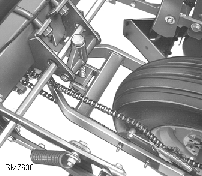 Ground-contact drive on an integral planter
Ground-contact drive on an integral planter
1705, 1715, and 1725 Planters (except 1725 16Row30) are driven from one rear-mounted, ground-contact wheel.
1735 Planter drive
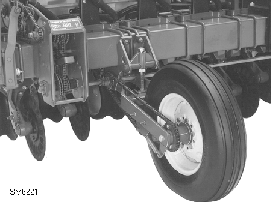 Front-mounted, ground-contact drive wheel
Front-mounted, ground-contact drive wheel
A 1735 Planter is driven by one front-mounted ground-contact wheel.
1755 Planter drive
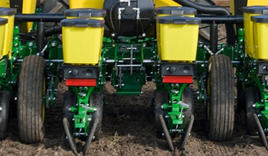 Ground-contact drive wheel on a 1755 Planter
Ground-contact drive wheel on a 1755 Planter
Using ground-contact drive wheels much like the integral planters, the 1755 Drawn Planter utilizes two drive wheels.
Vacuum system
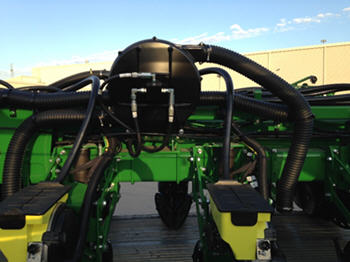 Vacuum system
Vacuum system
Vacuum blower assembly
 Vacuum blower shown on 1795
Vacuum blower shown on 1795

Vacuum is created by a hydraulically driven vacuum blower assembly mounted on the planter frame. The vacuum blower requires a tractor with a closed-center hydraulic system and a separate selective control valve (SCV). For tractors with open-center hydraulic system, a vacuum 540-rpm or 1000-rpm power take-off (PTO) driven hydraulic pump system is available. PTO pumps offered from the factory are limited to 15-row applications or less.
Different vacuum levels are required depending on the crop being planted. A hydraulic control valve lets the operator regulate vacuum blower speed, changing the vacuum level. On late-model John Deere tractors, vacuum levels are set from the tractor seat using the SCV controls. The control valve is not needed in those applications. At full flow, the system flows up to 18.9 L/min (5 gpm) per motor.
Convenient vacuum gauges located on the planter hitch give a visual indication of the vacuum level. When using a SeedStar™ monitor, the vacuum level can be displayed on the monitor. Consult the vacuum metering seed charts in the operator's manual for initial vacuum setting recommendations.
Vacuum meter case drain
 Case drain coupler 7000 Series Tractor
Case drain coupler 7000 Series Tractor

All planters with vacuum metering systems have case drain motors on the vacuum blowers. Case drain lines will have a flush-face case drain coupler on the planter and will require a corresponding flush-face case drain coupler on the tractor. The flush-face coupler simplifies implement attachment by allowing operators to easily identify the case drain. The unique hose tip is unable to connect to another coupler on the tractor, ensuring the correct setup.
It is important to connect this case drain hose to prevent the continuous and complete draining of hydraulic fluid due to the relief feature that opens the coupler when the pressure reaches 68.9 kPa (10 psi). This relief feature is designed to protect the motor shaft seal if for any reason the case drain hose was not connected to the tractor. The flush-face hose tips have less back pressure than ISO case drain tips, and the flat surface makes these couplers easy to clean, providing less chance for contamination.
The case drain line is also used with all Central Commodity System (CCS™) fan motors.
Features
1725NT Frame
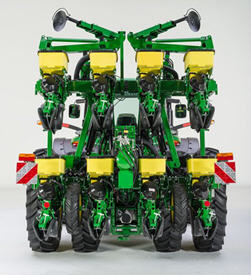 Stack-fold planter frame
Stack-fold planter frame
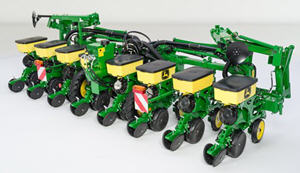 1725NT Planter frame
1725NT Planter frame
The 1725NT utilizes an integral, stack-fold frame that allows for a transport width of approximately 3.05 m (10 ft) and a height of just over 4 m (13 ft). Operators who drive on narrow roadways or work in small fields will find the narrow transport frame, without lift-assist wheels, to be especially useful in situations where maneuverability is limited.
This design also allows for the vacuum to be integrated into the frame without adding clutter to the bar. This means a cleaner look with better visibility from the operator station.
The 1725NT also includes 40.6-cm (16-in.) notched disk markers in the base machine, with an option for less markers. These markers act independent of the frame position and are controlled by a selective control valve (SCV). The notched disk design allows for a more aggressive marking capability, especially in minimum-till or no-till conditions.
MaxEmerge™ 5e overview

The MaxEmerge 5e is designed to improve population accuracy, spacing, and avoid wasting inputs for maximizing yield. The "e" in MaxEmerge 5e stands for electric drive. It is driven by one electric motor per meter with a small controller. This does away with the shafts and drivelines of a typical mechanical drive. That means more reliability, less maintenance, and easier access to row-unit components. For producers who want uniform seed spacing, the MaxEmerge 5e is a great option.
One of the biggest advantages of the MaxEmerge 5e is how it improves population accuracy by compensating for curves on the outer rows of the planter. The MaxEmerge 5e row-unit eliminates shafts and drivelines from the planter, allowing better access to row-unit components and decreased planter maintenance. Additionally, the MaxEmerge 5e allows corn and soybean growers to achieve up to a 20 percent improvement in population accuracy on the outer rows of a 24-row planter while planting on curves utilizing curve compensation.
While the MaxEmerge 5e uses a seed tube, it offers some of the same important advantages as ExactEmerge row units. The MaxEmerge 5e also improves reaction to population changes in the field when conditions dictate a higher or lower population, enabling producers to more accurately plant to the variable-rate prescription that maximizes profit potential. High-performance vacuum automation automatically maintains the target vacuum setting throughout the day with less time monitoring and making adjustments. It uses the SeedStar™ 4HP system and is compatible with Connect Mobile monitoring for near real-time, row-by-row planting performance. Depending on planter model, the MaxEmerge 5e package unlocks additional options like easy adjust row cleaners, Individual Row Hydraulic Downforce (IFHD), and pneumatic closing wheels.
The MaxEmerge 5e delivery system options include mini-hoppers with Central Commodity System (CCS™), 56.4-L (1.6-bu) hoppers, and 105.7-L (3-bu) hoppers.
NOTE: MaxEmerge 5e row-units are compatible with the following models: 1725NT, 1725C, 1725 CCS (not available on twin row), 1775NT, 1795, DB44, DB60, DB66, DB80, DB88, and DB90 (not available on 54R 50.8 cm [20 in.]).
Commodity storage
56.4-L (1.6 bu) hoppers available in base equipment
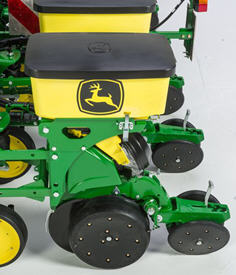 56.4-L (1.6-bu) hopper
56.4-L (1.6-bu) hopper
 Access to the meter under the hopper
Access to the meter under the hopper
The 1725NT utilizes a unique 56.4-L (1.6 bu) hopper that can be tilted and braced upwards to gain easy access to the meter for adjustments or cleanout.
This design also has a shutoff door to allow for meter access when seed is still in the hopper.
Vacuum automation
 Vacuum automation screen
Vacuum automation screen
Vacuum control has been defined. Before vacuum automation, an operator set the vacuum level by adjusting the hydraulic flow through each selective control valve (SCV). Many variables altered the vacuum level while the hydraulic flow stayed constant. This could have resulted in under or over populating, which may have impacted singulation. With vacuum automation, all that needs to be done is set the desired vacuum level and let the monitor do the work of adjusting the hydraulic flow. Should vacuum changes occur, the software in the monitor will fluctuate the SCV flow to achieve the desired vacuum level.
Vacuum automation requires SeedStar™ 4HP monitoring. The system controls SCV flow based on the vacuum pressure sensor. The tractor must be a John Deere with Tractor Electronic Control Unit (TECU) 3 controller area network (CAN) system for this feature to be compatible. The vacuum automation feature will control all vacuum fans if they are on their own SCVs. More vacuum fans make the planter more valuable and easier to operate.
Vacuum automation is not compatible with Interim Tier 4 (IT4) 6R Series Tractors.
Unit-mounted row cleaner with convenient screw adjustment
 Screw-adjust unit-mounted row cleaner
Screw-adjust unit-mounted row cleaner
Row cleaners are a valuable tool in reduced tillage planting conditions. The row cleaner helps to clear residue from the path of the opener, ensuring good row-unit operation. The row cleaner utilizes two angled wheels which engage the soil surface and residue, sweeping them aside.
Row cleaners provide many agronomic benefits, including quicker soil warmup and germination, and reduced hair pinning of residue into the seed furrow. Row cleaners can also provide a smoother ride for the gauge wheels, resulting in less row-unit bounce and a more uniform seeding depth.
The screw-adjust unit-mounted row cleaner is mounted directly to the face plate of the row-unit, placing the ground-engaging components just in front of the row-unit opener blades and depth gauge wheels. This close proximity allows the gauge wheels to control the depth of the row cleaner as well as the row-unit.
This compact design also allows greater compatibility with fertilizer openers and other planter attachments.
SharkTooth® wheels
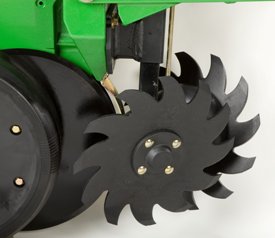 SharkTooth wheel
SharkTooth wheel
The unit-mounted row cleaner features the SharkTooth wheel. The beveled, sharpened edge of the teeth on the SharkTooth aggressively cut tough residue that lies in the path of the row-unit. The curved tooth design sweeps a clear path for the openers and resists residue buildup.
The wheels are arranged in a staggered fashion with one wheel leading the other, ensuring complete clearing of the row-unit path. The wheels can also be run side-by-side if desired, by simply relocating the wheels to existing holes on the row cleaner bracket.
The bearing on the SharkTooth wheel is sealed and requires no regular maintenance. Bearing shields are used between the wheel and the mount bracket to prevent residue wrapping and buildup around the bearing housing.
Adjustability
 Row cleaner adjustment knob
Row cleaner adjustment knob
The unit-mounted row cleaner offers a convenient screw adjustment feature for changing the depth setting. The acme screw is enclosed within the structure of the mounting bracket, providing protection from the elements.
The adjustment knob for the screw adjustment is accessible from the top of the parallel arms. The knob can be adjusted by hand, or by using a socket.
The adjustment is detented in 1.6-mm (1/16-in.) increments, allowing for quick, easily repeatable adjustments across all rows of the planter.
An indicator rod and scale on the front of the row cleaner bracket indicate the current setting. If a condition is encountered where use of the row cleaner is not desired, it can be set so that the wheels do not engage the soil surface.
Operational notes and compatibility
Use of row cleaners is not recommended when surface application pre-plant herbicide is used prior to planting. When using pre-plant incorporated herbicide, the row cleaner should be adjusted to minimize soil disturbance so as not to reduce the effectiveness of the incorporated herbicide.
Drive chain shields are recommended for use with row cleaner attachments.
Two different models of screw-adjust, unit-mounted row cleaners are available; the standard row cleaner for 762-mm (30-in.) row spacing and the narrow row cleaner for 508-mm (20-in.) or 558.8-mm (22-in.) row spacing.
NOTES:
-
Screw adjust, unit-mounted row cleaners are fully factory installed when ordered with the planter
-
Not compatible with use of frame-mounted coulter
-
Row spacing less than 762 mm (30 in.) requires the narrow row cleaner option.
-
For 1795 12/23, 12/24, 16/31, and 16/32 row machines, unit-mounted row cleaners are provided on the front rank of rows only.
-
For DB60 47R15 machines, unit-mounted row cleaners are provided on the row-units with short parallel arms only. They provide the 24 rows set on 762-mm (30-in.) spacing row cleaners.
-
Not compatible with the use combination of long parallel arms and MaxEmerge 5e row-units.
SharkTooth is a trademark of Yetter Manufacturing, Inc.
SeedStar™ 3 HP monitoring system
SeedStar 3 HP overview
 SeedStar 3 HP shown on the GreenStar™ 3 2630 Display
SeedStar 3 HP shown on the GreenStar™ 3 2630 Display

Building upon the foundation of previous SeedStar monitoring, the SeedStar 3 HP monitoring system takes planter monitoring to the next level. When paired with the GreenStar 3 2630 Display, the SeedStar 3 HP monitoring system provides critical information about the planting process to the operator within the tractor cab. SeedStar 3 HP is compatible with the GreenStar 3 2630, the Gen 4 4200 CommandCenter™ Display, the Gen 4 4600 CommandCenter Display, the 4240 Universal Display, and the 4640 Universal Display. SeedStar 3 HP is not compatible with the Gen 4 Extended Monitor.
Detailed planter performance information allows the operator to make adjustments needed for planter optimization. After all, with rising costs, it is imperative to make sure that every seed is planted accurately and precisely within the seed furrow for maximum yield potential.
The SeedStar 3 HP planting functions are fully integrated with the full spectrum of Precision Ag Technology applications such as John Deere Section Control for Planters, GreenStar 3 2630 Display, AutoTrac™ assisted steering system, John Deere Operations Center, JDLink™ telematics system, and others. Integrated planting technologies, for better asset utilization and ease of use, is just part of what SeedStar 3 HP provides.
SeedStar 3 HP main run page
 SeedStar 3 HP main run page
SeedStar 3 HP main run page
SeedStar 3 HP has an updated main run page layout. With the use of tabs toward the top of the screen it is much easier to navigate through readings such as population, singulation, spacing, downforce, and ride quality. If for some reason an issue arises with a row-unit, the tab will turn red indicating there is an issue. The tab can be pushed and lead to what is causing the issue. Inside each tab, there will be a bar graph detailing information specific to that tab. The picture shows what a population bar graph looks like. This layout improves functionality and overall ease of use while planting.
SeedStar 3 HP seed singulation monitoring
 SeedStar 3 HP seed singulation planter run page
SeedStar 3 HP seed singulation planter run page
Understanding meter singulation performance on the planter is critical to minimizing the amount of seed multiples and skips. As a result, the SeedStar 3 HP monitoring system provides real-time information, from the redesigned seed sensors placed in each belt cartridge, about the overall seed singulation performance.
As seen in the screen shot image to the left, overall singulation performance is seen in the tab at the top of the screen. Seed skip and multiple sources of information are displayed below the bar graph of the run page. This provides the operator a better understanding of relative seed multiple and skip data on a row-unit basis within one easy glance at this run page.
Also, within the seed singulation planter run page, information about row-units with the highest percentage of seed multiples and skips is provided in order to make necessary adjustments for better planter optimization.
SeedStar 3 HP row-unit downforce planter run page
 SeedStar 3 HP downforce planter run page
SeedStar 3 HP downforce planter run page
With changing field conditions, it is important to monitor down force to ensure consistent seed placement. Seeds placed too shallow or too deep can impact emergence and affect yield.
With the SeedStar 3 HP monitoring system, row-unit downforce information is measured by the downforce sensor and sensor nodes and transmitted to the GreenStar Display in the tractor cab. The row-unit downforce information is displayed on the top portion of this run page with more row-unit downforce information on the lower portion.
Active pneumatic downforce takes SeedStar 3 HP even further by removing constant downforce adjustments from the operator and actively controlling the downforce system to maintain a desired target margin. Just set the row-unit target margin value and the active pneumatic downforce system works automatically to make sure the planter maintains this value-achieving, precise soil penetration and consistent planting depth without sidewall soil compaction. This frees the operator from constantly making manual downforce adjustments as conditions change.


Depending on the planter size, different configurations of sensor nodes and downforce sensors are installed in support of the SeedStar 3 HP monitoring system.
SeedStar 3 HP is only available with the MaxEmerge 5e and ExactEmerge row-unit compatible planters built prior to model year 2018. Performance upgrade kits, DR models, and custom-built planters will continue to use SeedStar 3 HP in model year 2018.
SeedStar 3 HP ride quality and ground contact run page
 SeedStar 3 HP ride quality and ground contact run page
SeedStar 3 HP ride quality and ground contact run page
The fifth tab from the left in SeedStar 3 HP is a shared tab between ground contact and ride quality. Operators may change between the two criteria based on their planter setups or personal preferences. Ground contact displays the percentage of time the row-units are engaging the ground, the load is measured via a sensor through the gauge wheels. Ground contact is recommended when using ExactEmerge™ row-units to ensure the row-unit is maintaining proper depth at higher planting speeds.
SeedStar 3 HP seed spacing monitoring
 SeedStar 3 HP seed spacing planter run page
SeedStar 3 HP seed spacing planter run page
Throughout the planting process, obtaining good seed spacing is critical towards achieving plant growing conditions for maximum yield potential.
Today, many items are adjusted on the planter prior to planting to optimize overall seed spacing performance. But after such adjustments are made, information about the actual seed spacing performance during planting was missing within the planter monitoring system. With SeedStar 3 HP, seed spacing information is transmitted live via the GreenStar Display to show the operator exactly what is happening with the planter behind them.
The SeedStar 3 HP transmits seed spacing information onto the bar graph (shown to the left) for easy understanding of planter seed spacing performance. Also, information about seed skips and multiples are provided to help understand actual planter meter performance and other related system functions in order to make necessary adjustments if needed.
SeedStar 3 HP meter runoff page
 SeedStar 3 HP runoff page
SeedStar 3 HP runoff page
On SeedStar 3 HP, the meter runoff page allows growers to test meters before going to the field. Growers can now test the meters without removing them and have confidence in their planter’s performance before going to the field. Many parameters are able to be viewed during this test such as: singulation, seed count, skips, multiples, coefficient of variation (cv), etc. This test assures that the meter is in healthy condition and ready to plant when conditions are appropriate.
Other SeedStar 3 HP monitoring features include:
- Capable of monitoring individual row-unit and overall planter performance in terms of seed spacing, singulation, and row-unit downforce
- On-screen indication of sensor node/down force sensor assemblies once configured within the monitor settings application
- Full-color display icons for easy recognition and overall aesthetics
- Pneumatic downforce system controls with the GreenStar Display application
- A run page that allows operator to view relative population levels of all rows on one screen
- Mapping of actual and target seed rates can be mapped in APEX™ software
- Reprogrammable utilizing controller area network (CAN) via Service ADVISOR™ diagnostics system or Service ADVISOR Remote with JDLink™ subscription
- User-configurable high fertilizer pressure alarm that allows the operator to be warned when fertilizer pressure reaches a specific level
- Automatic Fast Start for SeedStar 3 HP. This ensures that seeds will be place accurately when starting from a stop.
- Automatic tractor speed source selection. When equipped with an 8000/9000 Series Tractor, the system selects the radar speed or allows for manual speed input selection.
Components and operation
 Planter main controller
Planter main controller
 Row-unit controller (RUC) with two electric motors
Row-unit controller (RUC) with two electric motors
The SeedStar 3 HP monitoring system contains the following components in order to support the planting data transfer to the GS Displays:
- Planter main controller
- Sensor node(s)
- Downforce sensor assembly
- Electric power gen controller
- Electric power gen (EPG)
- Row-unit controller (RUC)
The row-unit controller processes the row-unit data from the sensor node assemblies located on the row-unit head casting. The processed information is then sent to the planter main controller to be integrated into the displayed information being sent to the GreenStar Display.
Downforce sensor assemblies are found on row-units with sensor nodes installed. The downforce sensor assembly is put together with the gauge wheel depth-adjustment handle and provides gauge wheel pressure information to the respective sensor node for data processing.
Increase productivity with ExactEmerge™ trench delivery system and BrushBelt™ delivery system
It is very challenging to get the crop planted during the optimum planting window or as close to the optimum planting day as possible. Rate-of-yield loss accelerates greatly after the optimum window has passed. This is especially true in the northern U.S. and Canada. ExactEmerge maintains accurate speed placement at higher speeds; growers can avoid missing that peak planting time, thereby helping to get the highest crop yields.
 Yield loss after optimum planting day
Yield loss after optimum planting day

With the BrushBelt trench delivery system, the spacing in the trench does not change from even to uneven terrain. This can be a problem with a traditional seed tubes. Seed bounce and ricochet may occur as slopes increases, ultimately decreasing seed spacing performance.
The design of the BrushBelt system provides the best solution for the lowest release of seed to the bottom of the trench. The use of a brush provides the meter with an infinite amount of placement opportunities for each seed. This is what gives producers the confidence that every seed will have the desired spacing that a seed tube cannot provide.
 Maintenance-free BrushBelt system
Maintenance-free BrushBelt system

When the brush comes around the pulley, it expands and allows the seed to be transferred from the bowl to the brush very easily. The brush then carries the seed down toward the trench, ensuring that there is no movement as it moves down the length of the cartridge.
Once the brush reaches the lower pulley, the BrushBelt system expands again to loosen the grip on the seed, and the centrifugal force releases the seed. Another advantage with the BrushBelt system and cartridge at all speeds up to 10 mph is the ability to match the seed rearward trajectory to the forward ground speed of the planter. This provides a dead drop of the seed with no bounce and no roll at the bottom of the trench.
 BrushBelt conditioner engages brush bristles
BrushBelt conditioner engages brush bristles

John Deere’s ExactEmerge cartridge is self-cleaning. When an operator uses seed treatments or is forced to plant in less than ideal soil conditions, the design of the trench delivery system sheds buildup from the BrushBelt. A brush conditioner is located at the bottom of the cartridge to remove remaining residue and prevent the bristles from sticking together.
 Brush proximity helps clean sensor
Brush proximity helps clean sensor

Another advantage over a seed tube is that the BrushBelt system also acts as a cleaner to the seed sensor compared to a seed tube.
 BrushBelt removed from trench delivery system
BrushBelt removed from trench delivery system

The BrushBelt system requires no maintenance and has a wear life designed to match the wear life of the other wear components. Since operations vary, as do soils and field content, it is recommended to replace the BrushBelt after noticeable wear or decreased performance.
Changing the belt is easy. One latch removes the meter over the trench delivery system. Grab the cartridge by the grip and pull toward the body, releasing it from the electric motor fitting. Lift the trench delivery system up and remove the sensor wiring harness to completely pull the cartridge out of the row-unit.
There are two plastic covers that snap off to uncover the belt; remove the covers and then twist the circular spring-tensioner dial with the yellow arrow on it to release the tension on the springs. Once tension has been removed, pull the belt out. It is also recommended to change the stainless-steel wear strip at this time as well, which also slides right out of place without the use of tools.
NOTE: It is recommended to use a talc/graphite mixture with ExactEmerge. Best results have been 80 percent talc and 20 percent graphite. For certain regions and territories, talc and talc/graphite mixes are restricted from use; in this case, use a wax-based fluency agent.
Dual 56-V electric motors for ExactEmerge™ row-units
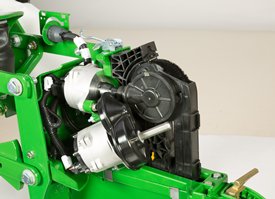 Two 56-V brushless electric motors
Two 56-V brushless electric motors
 Improve productivity with two 56-V brushless electric motors
Improve productivity with two 56-V brushless electric motors
Two 56-V brushless electric motors provide ExactEmerge the upper hand over any other row-unit on the market. One motor controls the high-performance meter and the other powers the BrushBelt™ delivery system. Both feature a closed loop system ensuring they operate at the correct rpm.
The motor is controlled at a rate of 200 times per second and a decision is made every 5 milliseconds. The controller also keeps each motor operating at independent speeds of each other. The meter speed is determined by a combination of ground speed and desired population rate while the BrushBelt speed stays consistent with the forward ground speed of the planter in order to place the seed at the bottom of trench.
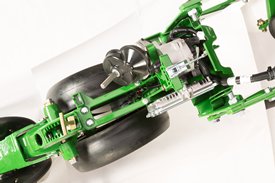 Brushless motors are maintenance free
Brushless motors are maintenance free

Industry-proven 56-V brushless motors give confidence to the operator that the row-unit will perform in any condition. The advantage of 56-V over 24-V electric motors is a lower amperage draw.
Brushless motors are maintenance free and give the producer the most optimal solution to achieve the highest performance and the lowest amount of work to the planter.
 Built-in RowCommand™ system
Built-in RowCommand™ system

Manage seed output, reduce yield drag, and improve harvest capabilities are features built in to every ExactEmerge row-unit with electric motor shutoffs.
The electric drive version of RowCommand row-unit has the potential to get 2 to 8 percent reduction in seed usage from being able to control the meter and BrushBelt rather than a clutch disengaging and some seeds still falling down the seed tube.
Sensors for trench delivery system on ExactEmerge™ planters
 Sensors for trench delivery system
Sensors for trench delivery system
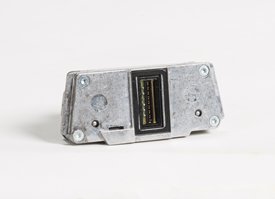 Reflective seed sensor
Reflective seed sensor
 Sensor on trench delivery system
Sensor on trench delivery system

On all ExactEmerge row-units, each cartridge will be equipped with sensors. As the seeds are being delivered through the BrushBelt™ delivery system controls, they pass the reflective seed sensor. The delivery system slides every seed past the seed sensor to read and send the signal to the controller. The seed sensor and design is able to provide sensor performance at higher seeds per second with no population adjustment as needed with seed tube sensors. This seed sensor data is actual row-unit performance data. In comparison, seed tube sensors add 10 percent population in soybean planting to adjust for the seeds missed due to placement within the seed tube. The BrushBelt system holds each seed in place until released in the trench, allowing the seed sensor a more accurate read.
Curve compensation

Terraces or waterways are two of many field obstacles that make planting on a curve challenging. When planters utilize drive shafts, they are not able to control each individual row-unit; as a result, planting on a curve presents an issue of maintaining 100 percent population. Since the inside rows are moving slower than the outside rows, the inside rows will be over populating while the outside rows are under populating.
With ExactEmerge™ planters and equipped MaxEmerge™ 5e planters, the curve compensation feature allows each row to receive an individual signal based on the speed at which the row-unit is moving, maintaining the correct population across the width of the planter. Without curve compensation, there could be as much as a 24 percent drop in population accuracy, which is equivalent to 8,600 seeds per acre when planting at 36,000 seeds per acre. Curve compensation measures acceleration within the main planter controller and utilizes speed inputs to ensure each row has the desired population accuracy.
Mobile row-unit runoff
 Row Runoff diagnostic test
Row Runoff diagnostic test
 The test functions from a mobile device
The test functions from a mobile device
 Determine optimum settings without being in the cab
Determine optimum settings without being in the cab
The first day of planting season can be as productive as the last with mobile row-unit runoff. The mobile row-unit runoff activation on the planter main controller (PMC) allows operators to make adjustments to maximize row-unit performance from a mobile device at the rear of the planter for both preseason and in-season use - all enabled through the PlanterPlus™ app.
Mobile row-unit runoff allows growers to perform test-stand functions from a mobile device connected to the planter.
The row runoff test provides complete diagnostic checks both preseason and in season. With the row-unit runoff test, the operator can make adjustments from the mobile device, including vacuum pressure, to determine the optimum meter and vacuum settings. This app functionality will help avoid making trips to the cab while validating meter performance.
During preseason planter inspections and set up, utilize the meter performance test to validate meter accuracy, similar to a test stand without leaving the farm. Test all systems on the planter, not just the meter, providing confidence that all planter systems are ready to plant. Reports are generated from the test providing information the operator can save and send for future reference.
Before heading to the field, the operator will benefit from knowing the best row-unit and vacuum settings for each variety selected to plant that spring.
Watch this video to see mobile row-unit runoff in action.
Mobile row-unit runoff will work with any model year 2015 or newer ExactEmerge™ or MaxEmerge™ 5e equipped planter. Mobile row-unit runoff can be added with attachment AA93169.
For model year 2018 and newer ExactEmerge planters, mobile row-unit runoff is included in base equipment. For model year 2018 and newer MaxEmerge 5e planters not equipped from the factory, mobile row-unit runoff can be added with attachment AA93169. A mobile row-unit runoff and Easy Fold package can be added with attachment AA97849 (only available with 1775NT and 1795 Planters with a 2-point hitch and model year 2019 and newer DB Planters with Gen 4 based frame folding).
NOTE: Mobile runoff utilizes PlanterPlus app available on select iPad® tablets, iPhone® smartphones, and Android™ devices.
Mobile row-unit runoff and Easy Fold aftermarket for field conversion kits
The below software bundles include the functionality explained above for machines not ordered with the feature from the factory. Compatible machines include all the necessary sensors and harnesses needed to make the feature function. The attachment part is software only. Follow the mobile runoff ordering and software push guide below for ordering and installation.
SeedStar™ 3 HP conversion to SeedStar 4HP with mobile row-unit runoff aftermarket for field conversion kits
Growers who are currently running model year 2017 planters, model year 2017 and newer performance upgrade kits, or model year 2017 and newer custom built-planters with the SeedStar 3 HP monitoring system can upgrade to the SeedStar 4HP monitoring system with mobile row-unit runoff. The attachment part, AA100382, is software only. The Gen 4 display software version will need to be 19-1 or newer and will require planter apps. Follow the mobile runoff ordering and software push guide below for ordering and installation. Performance upgraded planters and custom-built planters will also require the John Deere Connect Mobile kit, 0048PC, from the Precision Ag Technology Price Pages and wiring harness AA83662 to enable the mobile row-unit runoff feature. Please reference Parts Advisor and CCMS Solution 105181 for model-specific mounting brackets. SeedStar 4HP requires the Gen 4 4600 CommandCenter™ v2 display or 4640 Universal Display.
Mobile runoff ordering and software push guide
iPad and iPhone are trademarks of Apple Inc. Android is a trademark of Google LLC.
SeedStar™ 4HP monitoring system
SeedStar 4HP is designed to optimize the in-cab monitoring experience exclusively on the Gen 4 4600 CommandCenter™ display or 4640 Universal Display for growers with ExactEmerge™ planters and MaxEmerge™ 5e planters model year 2018 and newer. With SeedStar 4HP, operators will easily see key planter information with customizable run pages, zoom functionality, and simultaneous graph and performance measurements. SeedStar 4HP is included in base on all model year 2018 ExactEmerge and MaxEmerge 5e planters.
Features overview:
- View multiple planters' at-a-glance bar charts simultaneously
- Three default planter run pages show key planter functions in easy-to-view layouts
- Highly configurable run pages allow SeedStar modules to be customizable
- Zoom feature allows quick row-by-row detailed information
- View dual bar graphs to see multiple planter details at one time
- SeedStar application to make adjustments to planter functions
- Simplified setup through the work set-up page
- Custom rates allow up to six different rates across 48 rows
- The SeedStar 4HP monitoring system requires the Gen 4 4600 CommandCenter or 4640 Universal Display. These displays allow the operator to benefit from the updated interface, enhanced processing speeds, and easy setup (learn more here).
SeedStar 3 HP conversion to SeedStar 4HP with mobile row-unit runoff aftermarket for field conversion kits
Growers who are currently running model year 2017 planters, model year 2017 and newer retrofit kits, or model year 2017 and newer custom-built planters with the SeedStar 3 HP monitoring system can upgrade to the SeedStar 4HP monitoring system with mobile row-unit runoff. The attachment part, AA100382, is software only. The Gen 4 display software version will need to be 19-1 or newer and will require planter apps. Follow the mobile runoff ordering and software push guide below for ordering and installation. Retrofitted planters and custom-built planters will also require the John Deere Connect Mobile kit, 0048PC, from the Precision Ag Technology Price Pages and wiring harness AA83662 to enable the mobile row-unit runoff feature. Please reference Parts Advisor and CCMS Solution 105181 for model-specific mounting brackets. SeedStar 4HP requires the Gen 4 4600 CommandCenter™ v2 display or 4640 Universal Display.
Default planter run pages
 Planter summary default run page
Planter summary default run page
 Planter overview default run page
Planter overview default run page
 Planter details default run page
Planter details default run page
Three default run pages show key planter functions in different views to give fast and easy access to important planter information.
Custom run pages
 Customizable run pages
Customizable run pages
There are customizable run pages that allow the operator to build pages that fit their operation with different modules, like the example shown above.
Zoom functionality
 Zoom feature showing a group of rows
Zoom feature showing a group of rows
 Zoom feature showing a single row
Zoom feature showing a single row
The zoom feature allows the operator to touch a section or row of the planter and get detailed information quickly.
Dual bar graphs
 Dual bar graph showing singulation and population simultaneously
Dual bar graph showing singulation and population simultaneously
Dual bar graphs allow operators to view multiple planter details at one time.
SeedStar application page
 SeedStar application run page
SeedStar application run page
In the SeedStar application, many adjustments can be made, including manually activating section control. SeedStar 4HP allows up to 48 individual row sections. There are several setup features such as crop, seed disk, number of rows being planted, population alarms, and limits. Seed rates can be modified, electric power generation (EPG) can be turned on or off, vacuum can be adjusted, and the fill and purge functions can be used from the SeedStar application. Frame control, as well as diagnostics and calibrations, can be accessed at the bottom of the screen.
Settings Manager in SeedStar 4HP
 Settings Manager screens
Settings Manager screens

Reduce set-up time between changing crops or field conditions by recalling saved settings used previously with Settings Manager, included with every SeedStar 4HP system. This feature allows saving and recalling planter and tractor settings for optimum performance in different conditions.
Settings Manager can be used to save all of the adjustment and inputs associated to a particular crop or condition. An example would be to store all population rates, downforce pressure, row cleaner adjustments, and closing wheel settings for planting corn and storing a separate, unique set of adjustments for soybeans. In addition, Settings Manager stores tractor settings such as selective control valve (SCV) flow and detents, infinitely variable transmission (IVT™) settings, eco modes, and more.
Custom rates in SeedStar 4HP
 Variety set-up page
Variety set-up page
 Rate set-up page
Rate set-up page
 Group rate set-up page
Group rate set-up page
Custom rates allow for individual row population control and row-by-row documentation where up to six different rates can be assigned across an up to 48-row planter. This allows growers interested in planting seed corn with ExactEmerge or MaxEmerge 5e the capability to assign specific populations to male and female rows for planting. This feature can also be used to create tram lines or other applications where custom rates by row are needed.
NOTE: Individual rates are tied to varieties, so each individual rate needs a unique variety name.
Compatibility
| SeedStar 4HP compatibility | |
| Planters | All models ordered with ExactEmerge or MaxEmerge 5e row-units NOTE: Retrofit kits are equipped with SeedStar 3HP only, but can be upgraded by purchasing part number AA100382. |
| Displays | Gen 4 4600 CommandCenter equipped with Version 2 Processor or 4640 Universal Display Dual-display mode is compatible with mid model year 2019 planter software. |
| Active Implement Guidance (AIG) | Compatible with SeedStar 4HP on Gen 4 displays with VT mode and required activations and subscriptions |
| AutoTrac™ Implement Guidance | Not compatible |
| AutoTrac Turn Automation | Not compatible |
Additional information
For additional information on feature functionality on the Gen 4 Display, visit the links below:
YouTube is a trademark of Google LLC.
Features
1725C Planter – integral stack folding
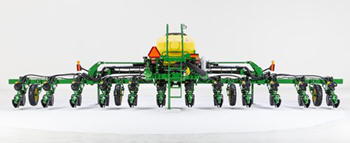 Convenient stack-folding design can be used rigid or flexible
Convenient stack-folding design can be used rigid or flexible
The 1725C stack-fold design provides narrow transport capability for these integral, large-frame planters. 1725C Stack-Fold Planters have the ability to operate in both rigid-frame and flex-frame configurations. The 1725C utilizes a three-section frame that can flex up to 8 degrees up and 8 degrees down. 1725C is not offered with markers.
The 1725C Stack-Fold Integral Planter is available in the following configurations: 12Row36, 12Row38, or 12Row40.
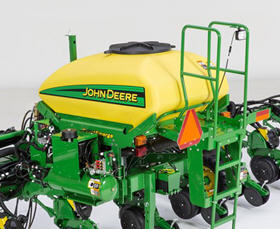
The 1725C is only available without lift-assist wheels. This allows for increased maneuverability around tighter field conditions and bedded crops.
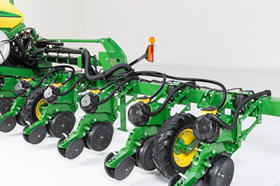 Vacuum run through the frame provides a cleaner look
Vacuum run through the frame provides a cleaner look
The vacuum is run through the planter frame rather than the black conduit on top of the frame. This cleaner frame design provides improved visibility when seated in the cab.
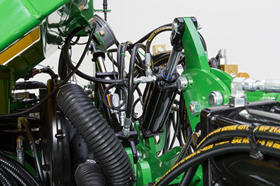 Hydraulic cylinder on 1725C frame for wing downforce/gull wing functionality
Hydraulic cylinder on 1725C frame for wing downforce/gull wing functionality
Optional wing downforce/gull wing is available on the 1725C. When traveling at speeds above 8.05 km/h (5 mph), the wings may become lighter, sacrificing ground contact and consistent depth. Hydraulic cylinders have been added to maintain force on the outer wings to keep desired depth. Operators also have the ability to pin the outer wings rigid with or without the wing downforce/gull wing option.
The same cylinders are used to enable the gull-wing feature on the 1725C. The gull wing flexes the outer wing up to 8 degrees upward, allowing for more vertical wing clearance.
Uptime
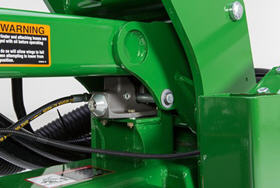 Hydraulic locking mechanism for in-cab wing locking
Hydraulic locking mechanism for in-cab wing locking
An automatic hydraulic-wing locking feature is available on the 1725C. Once the operator engages the frame-fold selective control valve (SCV), the hydraulics release the locking mechanism and the planter starts folding. This reduces trips up and down the tractor and provides for a much quicker fold/unfold process.
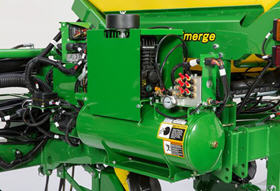 Active pneumatic downforce compressor
Active pneumatic downforce compressor
Active pneumatic downforce is in base on the 1725C. This provides the proven downforce solution for growers to maintain consistent depths even at speeds up to 16.1 km/h (10 mph).
1725C Central Commodity System (CCS™)
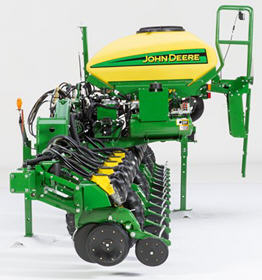 1233.4-L (35-bu) 1725C CCS
1233.4-L (35-bu) 1725C CCS
CCS seed delivery adds productivity through increased seed capacity, bulk-fill capability, and easy cleanout.
The single tank on the 1725C has a capacity of 1233.4 L (35 bu). CCS tanks are manufactured using a rotomolded, polyethylene design to ensure maximum durability. The translucent tank allows for easy viewing of seed in the tanks.
The following crops can be planted with CCS: corn, sweet corn, popcorn, cotton, sunflowers, soybeans, and sorghum (milo).
Filling the tank is convenient due to a central filling location. The ladder provides access to the filling platform. The tank has an adjustable bin-level sensor to alert the operator when it is time to fill.
For those who work into the night, a standard fill light package is available on machines equipped with CCS. This option includes one light conveniently mounted on the railing of the machine. The lights are turned on and off with their own switch located at the bottom of the ladder.
Seed delivery process
CCS is about reducing the time spent filling the planter with seed while maximizing the time spent planting. CCS for planters is a form of seed handling and delivery. The row-units perform the final task of seed metering and placement.
The CCS seed delivery process relies on a hydraulically driven fan to move seed from the CCS tank to the row-units. When the planter is lowered, hydraulic flow is sent to the seed delivery fan. A flow control valve and gauge, located near the tank, allows for the proper tank pressure setting based on seed type.
Air from the fan pressurizes the CCS tanks and delivers seed to the seed hoppers. Airflow enters the seed tank through a nozzle in the manifold which pressurizes the tank. The air then picks up seed and moves out the other end of the nozzle into the seed delivery hoses. These hoses route the seed toward the hopper. A small amount of seed is traveling in the delivery hoses only when needed.
The hopper fills with seed until the delivery hose (discharge elbow) is covered. Once the opening is restricted, seed flow through the hose stops. Air flowing to the row-unit travels into the hopper and is vented, which is the source of air for the vacuum system. This provides a much cleaner air source than previous meter designs. As the seed is picked up by the meter and planted, the seed pool shrinks until the end of the delivery hose is uncovered. At that time, the airflow and seed delivery resume and the seed pool in the hopper is replenished.
CCS seed cleanout
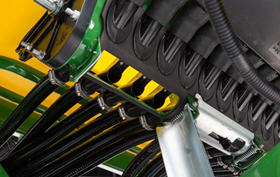 CCS seed cleanout
CCS seed cleanout
Seed cleanout could not be easier with a CCS planter. When the operator is finished planting, any remaining seed can simply be removed via access doors at the bottom of the CCS tank.
Because seed is only traveling through the CCS delivery hoses when required by the meter, there is not much left to clean.
Next, CCS seed delivery hoses are purged with air from the CCS fan, and the excess seed is pushed to the individual meters.
Lastly, the vacuum meter door is opened, and seed is removed with the supplied catch pan.
Small-seed CCS components
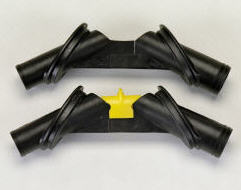 Manifold nozzle and nozzle with cover installed
Manifold nozzle and nozzle with cover installed
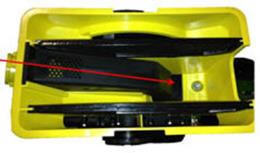 Straight-seed inlet installed in mini-hopper
Straight-seed inlet installed in mini-hopper
The CCS seed delivery system increases planting productivity across the seven approved crops listed above. While highly effective when delivering seed from the CCS tanks to the vacuum meters, small or light seeds (sorghum and small cotton) will require two additional components to aid in proper seed delivery.
Manifold nozzle covers (clips) should be installed to ensure seed is adequately picked up into the air stream for delivery to the row-unit. Mini-hopper discharge elbows should also be changed from the standard elbow (holes) to the small-seed elbow (slotted openings) when planting sorghum (milo) and small cotton.
MaxEmerge™ 5e overview

The MaxEmerge 5e is designed to improve population accuracy, spacing, and avoid wasting inputs for maximizing yield. The "e" in MaxEmerge 5e stands for electric drive. It is driven by one electric motor per meter with a small controller. This does away with the shafts and drivelines of a typical mechanical drive. That means more reliability, less maintenance, and easier access to row-unit components. For producers who want uniform seed spacing, the MaxEmerge 5e is a great option.
One of the biggest advantages of the MaxEmerge 5e is how it improves population accuracy by compensating for curves on the outer rows of the planter. The MaxEmerge 5e row-unit eliminates shafts and drivelines from the planter, allowing better access to row-unit components and decreased planter maintenance. Additionally, the MaxEmerge 5e allows corn and soybean growers to achieve up to a 20 percent improvement in population accuracy on the outer rows of a 24-row planter while planting on curves utilizing curve compensation.
While the MaxEmerge 5e uses a seed tube, it offers some of the same important advantages as ExactEmerge row units. The MaxEmerge 5e also improves reaction to population changes in the field when conditions dictate a higher or lower population, enabling producers to more accurately plant to the variable-rate prescription that maximizes profit potential. High-performance vacuum automation automatically maintains the target vacuum setting throughout the day with less time monitoring and making adjustments. It uses the SeedStar™ 4HP system and is compatible with Connect Mobile monitoring for near real-time, row-by-row planting performance. Depending on planter model, the MaxEmerge 5e package unlocks additional options like easy adjust row cleaners, Individual Row Hydraulic Downforce (IFHD), and pneumatic closing wheels.
The MaxEmerge 5e delivery system options include mini-hoppers with Central Commodity System (CCS™), 56.4-L (1.6-bu) hoppers, and 105.7-L (3-bu) hoppers.
NOTE: MaxEmerge 5e row-units are compatible with the following models: 1725NT, 1725C, 1725 CCS (not available on twin row), 1775NT, 1795, DB44, DB60, DB66, DB80, DB88, and DB90 (not available on 54R 50.8 cm [20 in.]).
Curve compensation

Terraces or waterways are two of many field obstacles that make planting on a curve challenging. When planters utilize drive shafts, they are not able to control each individual row-unit; as a result, planting on a curve presents an issue of maintaining 100 percent population. Since the inside rows are moving slower than the outside rows, the inside rows will be over populating while the outside rows are under populating.
With ExactEmerge™ planters and equipped MaxEmerge™ 5e planters, the curve compensation feature allows each row to receive an individual signal based on the speed at which the row-unit is moving, maintaining the correct population across the width of the planter. Without curve compensation, there could be as much as a 24 percent drop in population accuracy, which is equivalent to 8,600 seeds per acre when planting at 36,000 seeds per acre. Curve compensation measures acceleration within the main planter controller and utilizes speed inputs to ensure each row has the desired population accuracy.
Easy Adjust row cleaners
 Coulter combo row cleaner
Coulter combo row cleaner
 Easy Adjust row cleaner
Easy Adjust row cleaner
Easy Adjust row cleaner and coulter combo provides a pneumatic row tillage solution that is controlled from the seat of the tractor.
Every decision to make an adjustment during spring planting reduces the acres planted per day and can increase or decrease profitability. An adjustment that can be overlooked is row cleaners due to planter size, difficulty to make the adjustment, and varying conditions across fields and time.
 GreenStar™ 3 2630 Display view for row cleaners compatible with SeedStar™ 3 HP
GreenStar™ 3 2630 Display view for row cleaners compatible with SeedStar™ 3 HP
 4600 CommandCenter™ Display and 4640 Universal Display view for row cleaners compatible with SeedStar 4HP
4600 CommandCenter™ Display and 4640 Universal Display view for row cleaners compatible with SeedStar 4HP
With the Easy Adjust row cleaners on ExactEmerge™ planters, operators now have a pneumatic solution to make on-the-go adjustments that is controlled directly from the seat of the cab. They can be raised from the cab as needed with the push of a button for wet areas, waterways, or end rows. For growers using SeedStar 3 HP, the row cleaners are completely integrated into the John Deere GreenStar 3 2630 Display as well as the Gen 4 4600 CommandCenter display or 4640 Universal Display. For growers using SeedStar 4HP, a 4600 CommandCenter display or 4640 Universal Display is required.
The Easy Adjust row cleaners have the capability to save three presets for varying ground engagement based on field conditions. The system is controlled in three sections: at each wing as well as the center (frame or wheel) track rows. The pneumatic lines use air from the active pneumatic downforce compressor, requiring no additional compressor to be installed on the planter. The Easy Adjust row cleaners utilize down and up force air bags. The adjustable air pressure setting for each bag allows the operator to set the ride of the row cleaner depending on the field conditions and the desired results. Making these on-the-go adjustments from tractor cab increases productivity and performance during planting.
For Easy Adjust row cleaner performance upgrade kit options, see the ordering guide.
The row cleaner-only option utilizes parallel linkage to provide the floating action growers require in their fields. Parallel linkage allows for the unit to float up and down in the situation of hills or hard objects. The cleaner and coulter combo does not have parallel linkage, however, the row cleaners have floating rings installed to help provide the same benefits.
The row cleaners utilize the field-proven SharkTooth® design. Row cleaners play a major role in maximizing yield toward uniform emergence, reducing row-unit bounce, and maintaining proper depth. The Easy Adjust row cleaners provide growers with quick and stress-free solutions to customizing the planter in variable field conditions. They are available on ExactEmerge and MaxEmerge 5e equipped planters. They are not integrated into the RowCommand™ feature.
SharkTooth is a trademark of Yetter Manufacturing Incorporated.
Increase productivity with ExactEmerge™ trench delivery system and BrushBelt™ delivery system
It is very challenging to get the crop planted during the optimum planting window or as close to the optimum planting day as possible. Rate-of-yield loss accelerates greatly after the optimum window has passed. This is especially true in the northern U.S. and Canada. ExactEmerge maintains accurate speed placement at higher speeds; growers can avoid missing that peak planting time, thereby helping to get the highest crop yields.
 Yield loss after optimum planting day
Yield loss after optimum planting day

With the BrushBelt trench delivery system, the spacing in the trench does not change from even to uneven terrain. This can be a problem with a traditional seed tubes. Seed bounce and ricochet may occur as slopes increases, ultimately decreasing seed spacing performance.
The design of the BrushBelt system provides the best solution for the lowest release of seed to the bottom of the trench. The use of a brush provides the meter with an infinite amount of placement opportunities for each seed. This is what gives producers the confidence that every seed will have the desired spacing that a seed tube cannot provide.
 Maintenance-free BrushBelt system
Maintenance-free BrushBelt system

When the brush comes around the pulley, it expands and allows the seed to be transferred from the bowl to the brush very easily. The brush then carries the seed down toward the trench, ensuring that there is no movement as it moves down the length of the cartridge.
Once the brush reaches the lower pulley, the BrushBelt system expands again to loosen the grip on the seed, and the centrifugal force releases the seed. Another advantage with the BrushBelt system and cartridge at all speeds up to 10 mph is the ability to match the seed rearward trajectory to the forward ground speed of the planter. This provides a dead drop of the seed with no bounce and no roll at the bottom of the trench.
 BrushBelt conditioner engages brush bristles
BrushBelt conditioner engages brush bristles

John Deere’s ExactEmerge cartridge is self-cleaning. When an operator uses seed treatments or is forced to plant in less than ideal soil conditions, the design of the trench delivery system sheds buildup from the BrushBelt. A brush conditioner is located at the bottom of the cartridge to remove remaining residue and prevent the bristles from sticking together.
 Brush proximity helps clean sensor
Brush proximity helps clean sensor

Another advantage over a seed tube is that the BrushBelt system also acts as a cleaner to the seed sensor compared to a seed tube.
 BrushBelt removed from trench delivery system
BrushBelt removed from trench delivery system

The BrushBelt system requires no maintenance and has a wear life designed to match the wear life of the other wear components. Since operations vary, as do soils and field content, it is recommended to replace the BrushBelt after noticeable wear or decreased performance.
Changing the belt is easy. One latch removes the meter over the trench delivery system. Grab the cartridge by the grip and pull toward the body, releasing it from the electric motor fitting. Lift the trench delivery system up and remove the sensor wiring harness to completely pull the cartridge out of the row-unit.
There are two plastic covers that snap off to uncover the belt; remove the covers and then twist the circular spring-tensioner dial with the yellow arrow on it to release the tension on the springs. Once tension has been removed, pull the belt out. It is also recommended to change the stainless-steel wear strip at this time as well, which also slides right out of place without the use of tools.
NOTE: It is recommended to use a talc/graphite mixture with ExactEmerge. Best results have been 80 percent talc and 20 percent graphite. For certain regions and territories, talc and talc/graphite mixes are restricted from use; in this case, use a wax-based fluency agent.
Dual 56-V electric motors for ExactEmerge™ row-units
 Two 56-V brushless electric motors
Two 56-V brushless electric motors
 Improve productivity with two 56-V brushless electric motors
Improve productivity with two 56-V brushless electric motors
Two 56-V brushless electric motors provide ExactEmerge the upper hand over any other row-unit on the market. One motor controls the high-performance meter and the other powers the BrushBelt™ delivery system. Both feature a closed loop system ensuring they operate at the correct rpm.
The motor is controlled at a rate of 200 times per second and a decision is made every 5 milliseconds. The controller also keeps each motor operating at independent speeds of each other. The meter speed is determined by a combination of ground speed and desired population rate while the BrushBelt speed stays consistent with the forward ground speed of the planter in order to place the seed at the bottom of trench.
 Brushless motors are maintenance free
Brushless motors are maintenance free

Industry-proven 56-V brushless motors give confidence to the operator that the row-unit will perform in any condition. The advantage of 56-V over 24-V electric motors is a lower amperage draw.
Brushless motors are maintenance free and give the producer the most optimal solution to achieve the highest performance and the lowest amount of work to the planter.
 Built-in RowCommand™ system
Built-in RowCommand™ system

Manage seed output, reduce yield drag, and improve harvest capabilities are features built in to every ExactEmerge row-unit with electric motor shutoffs.
The electric drive version of RowCommand row-unit has the potential to get 2 to 8 percent reduction in seed usage from being able to control the meter and BrushBelt rather than a clutch disengaging and some seeds still falling down the seed tube.
Sensors for trench delivery system on ExactEmerge™ planters
 Sensors for trench delivery system
Sensors for trench delivery system
 Reflective seed sensor
Reflective seed sensor
 Sensor on trench delivery system
Sensor on trench delivery system

On all ExactEmerge row-units, each cartridge will be equipped with sensors. As the seeds are being delivered through the BrushBelt™ delivery system controls, they pass the reflective seed sensor. The delivery system slides every seed past the seed sensor to read and send the signal to the controller. The seed sensor and design is able to provide sensor performance at higher seeds per second with no population adjustment as needed with seed tube sensors. This seed sensor data is actual row-unit performance data. In comparison, seed tube sensors add 10 percent population in soybean planting to adjust for the seeds missed due to placement within the seed tube. The BrushBelt system holds each seed in place until released in the trench, allowing the seed sensor a more accurate read.
Mobile row-unit runoff
 Row Runoff diagnostic test
Row Runoff diagnostic test
 The test functions from a mobile device
The test functions from a mobile device
 Determine optimum settings without being in the cab
Determine optimum settings without being in the cab
The first day of planting season can be as productive as the last with mobile row-unit runoff. The mobile row-unit runoff activation on the planter main controller (PMC) allows operators to make adjustments to maximize row-unit performance from a mobile device at the rear of the planter for both preseason and in-season use - all enabled through the PlanterPlus™ app.
Mobile row-unit runoff allows growers to perform test-stand functions from a mobile device connected to the planter.
The row runoff test provides complete diagnostic checks both preseason and in season. With the row-unit runoff test, the operator can make adjustments from the mobile device, including vacuum pressure, to determine the optimum meter and vacuum settings. This app functionality will help avoid making trips to the cab while validating meter performance.
During preseason planter inspections and set up, utilize the meter performance test to validate meter accuracy, similar to a test stand without leaving the farm. Test all systems on the planter, not just the meter, providing confidence that all planter systems are ready to plant. Reports are generated from the test providing information the operator can save and send for future reference.
Before heading to the field, the operator will benefit from knowing the best row-unit and vacuum settings for each variety selected to plant that spring.
Watch this video to see mobile row-unit runoff in action.
Mobile row-unit runoff will work with any model year 2015 or newer ExactEmerge™ or MaxEmerge™ 5e equipped planter. Mobile row-unit runoff can be added with attachment AA93169.
For model year 2018 and newer ExactEmerge planters, mobile row-unit runoff is included in base equipment. For model year 2018 and newer MaxEmerge 5e planters not equipped from the factory, mobile row-unit runoff can be added with attachment AA93169. A mobile row-unit runoff and Easy Fold package can be added with attachment AA97849 (only available with 1775NT and 1795 Planters with a 2-point hitch and model year 2019 and newer DB Planters with Gen 4 based frame folding).
NOTE: Mobile runoff utilizes PlanterPlus app available on select iPad® tablets, iPhone® smartphones, and Android™ devices.
Mobile row-unit runoff and Easy Fold aftermarket for field conversion kits
The below software bundles include the functionality explained above for machines not ordered with the feature from the factory. Compatible machines include all the necessary sensors and harnesses needed to make the feature function. The attachment part is software only. Follow the mobile runoff ordering and software push guide below for ordering and installation.
SeedStar™ 3 HP conversion to SeedStar 4HP with mobile row-unit runoff aftermarket for field conversion kits
Growers who are currently running model year 2017 planters, model year 2017 and newer performance upgrade kits, or model year 2017 and newer custom built-planters with the SeedStar 3 HP monitoring system can upgrade to the SeedStar 4HP monitoring system with mobile row-unit runoff. The attachment part, AA100382, is software only. The Gen 4 display software version will need to be 19-1 or newer and will require planter apps. Follow the mobile runoff ordering and software push guide below for ordering and installation. Performance upgraded planters and custom-built planters will also require the John Deere Connect Mobile kit, 0048PC, from the Precision Ag Technology Price Pages and wiring harness AA83662 to enable the mobile row-unit runoff feature. Please reference Parts Advisor and CCMS Solution 105181 for model-specific mounting brackets. SeedStar 4HP requires the Gen 4 4600 CommandCenter™ v2 display or 4640 Universal Display.
Mobile runoff ordering and software push guide
iPad and iPhone are trademarks of Apple Inc. Android is a trademark of Google LLC.
Increase job performance when planting and spraying
 Connect Mobile comparison map lets users compare two quality layers at once for planting and spraying
Connect Mobile comparison map lets users compare two quality layers at once for planting and spraying
Connect Mobile overview
John Deere Connect Mobile is a solution that utilizes an Apple® iPad® tablet in the cab and helps the operator increase job performance during planting and spraying operations. Connect Mobile documents and displays multiple quality layers, helping the operator monitor and more easily detect problems that can occur during planting and spraying. Connect Mobile also has a common user interface that makes it easy to use between different pieces of John Deere equipment.
Planting attributes
Monitor and document key performance indicators in high-definition map layers and dashboard tiles such as:
- Actual population
- Target population
- Singulation
- Seed-spacing CV
- Applied downforce
- Gauge wheel margin
- Ride quality
- Ground speed
- Variety
Spraying attributes
- Actual rate
- Rate deviation
- Ground speed
- Pressure
In base equipment
Planting
Connect Mobile hardware is factory installed on all model year 2015 and newer planters factory installed with ExactEmerge™ row-units and all model year 2017 and newer planters factory installed with MaxEmerge™ 5e row-units, making it easy to get started with Connect Mobile.
Spraying
Connect Mobile hardware is factory installed on all model year 2018 Sprayers with the 4600 CommandCenter™ display. Producers can also retrofit Connect Mobile on older sprayers with a GreenStar™ 3 2630 Display by installing the sprayer field kit.
Learn more about Connect Mobile in the Field and Crop Solutions section within the Precision Ag Technology product line and how it can improve the quality of a planting and spraying job.
iPad and Apple are trademarks of Apple Inc.
SeedStar™ 4HP monitoring system
SeedStar 4HP is designed to optimize the in-cab monitoring experience exclusively on the Gen 4 4600 CommandCenter™ display or 4640 Universal Display for growers with ExactEmerge™ planters and MaxEmerge™ 5e planters model year 2018 and newer. With SeedStar 4HP, operators will easily see key planter information with customizable run pages, zoom functionality, and simultaneous graph and performance measurements. SeedStar 4HP is included in base on all model year 2018 ExactEmerge and MaxEmerge 5e planters.
Features overview:
- View multiple planters' at-a-glance bar charts simultaneously
- Three default planter run pages show key planter functions in easy-to-view layouts
- Highly configurable run pages allow SeedStar modules to be customizable
- Zoom feature allows quick row-by-row detailed information
- View dual bar graphs to see multiple planter details at one time
- SeedStar application to make adjustments to planter functions
- Simplified setup through the work set-up page
- Custom rates allow up to six different rates across 48 rows
- The SeedStar 4HP monitoring system requires the Gen 4 4600 CommandCenter or 4640 Universal Display. These displays allow the operator to benefit from the updated interface, enhanced processing speeds, and easy setup (learn more here).
SeedStar 3 HP conversion to SeedStar 4HP with mobile row-unit runoff aftermarket for field conversion kits
Growers who are currently running model year 2017 planters, model year 2017 and newer retrofit kits, or model year 2017 and newer custom-built planters with the SeedStar 3 HP monitoring system can upgrade to the SeedStar 4HP monitoring system with mobile row-unit runoff. The attachment part, AA100382, is software only. The Gen 4 display software version will need to be 19-1 or newer and will require planter apps. Follow the mobile runoff ordering and software push guide below for ordering and installation. Retrofitted planters and custom-built planters will also require the John Deere Connect Mobile kit, 0048PC, from the Precision Ag Technology Price Pages and wiring harness AA83662 to enable the mobile row-unit runoff feature. Please reference Parts Advisor and CCMS Solution 105181 for model-specific mounting brackets. SeedStar 4HP requires the Gen 4 4600 CommandCenter™ v2 display or 4640 Universal Display.
Default planter run pages
 Planter summary default run page
Planter summary default run page
 Planter overview default run page
Planter overview default run page
 Planter details default run page
Planter details default run page
Three default run pages show key planter functions in different views to give fast and easy access to important planter information.
Custom run pages
 Customizable run pages
Customizable run pages
There are customizable run pages that allow the operator to build pages that fit their operation with different modules, like the example shown above.
Zoom functionality
 Zoom feature showing a group of rows
Zoom feature showing a group of rows
 Zoom feature showing a single row
Zoom feature showing a single row
The zoom feature allows the operator to touch a section or row of the planter and get detailed information quickly.
Dual bar graphs
 Dual bar graph showing singulation and population simultaneously
Dual bar graph showing singulation and population simultaneously
Dual bar graphs allow operators to view multiple planter details at one time.
SeedStar application page
 SeedStar application run page
SeedStar application run page
In the SeedStar application, many adjustments can be made, including manually activating section control. SeedStar 4HP allows up to 48 individual row sections. There are several setup features such as crop, seed disk, number of rows being planted, population alarms, and limits. Seed rates can be modified, electric power generation (EPG) can be turned on or off, vacuum can be adjusted, and the fill and purge functions can be used from the SeedStar application. Frame control, as well as diagnostics and calibrations, can be accessed at the bottom of the screen.
Settings Manager in SeedStar 4HP
 Settings Manager screens
Settings Manager screens

Reduce set-up time between changing crops or field conditions by recalling saved settings used previously with Settings Manager, included with every SeedStar 4HP system. This feature allows saving and recalling planter and tractor settings for optimum performance in different conditions.
Settings Manager can be used to save all of the adjustment and inputs associated to a particular crop or condition. An example would be to store all population rates, downforce pressure, row cleaner adjustments, and closing wheel settings for planting corn and storing a separate, unique set of adjustments for soybeans. In addition, Settings Manager stores tractor settings such as selective control valve (SCV) flow and detents, infinitely variable transmission (IVT™) settings, eco modes, and more.
Custom rates in SeedStar 4HP
 Variety set-up page
Variety set-up page
 Rate set-up page
Rate set-up page
 Group rate set-up page
Group rate set-up page
Custom rates allow for individual row population control and row-by-row documentation where up to six different rates can be assigned across an up to 48-row planter. This allows growers interested in planting seed corn with ExactEmerge or MaxEmerge 5e the capability to assign specific populations to male and female rows for planting. This feature can also be used to create tram lines or other applications where custom rates by row are needed.
NOTE: Individual rates are tied to varieties, so each individual rate needs a unique variety name.
Compatibility
| SeedStar 4HP compatibility | |
| Planters | All models ordered with ExactEmerge or MaxEmerge 5e row-units NOTE: Retrofit kits are equipped with SeedStar 3HP only, but can be upgraded by purchasing part number AA100382. |
| Displays | Gen 4 4600 CommandCenter equipped with Version 2 Processor or 4640 Universal Display Dual-display mode is compatible with mid model year 2019 planter software. |
| Active Implement Guidance (AIG) | Compatible with SeedStar 4HP on Gen 4 displays with VT mode and required activations and subscriptions |
| AutoTrac™ Implement Guidance | Not compatible |
| AutoTrac Turn Automation | Not compatible |
Additional information
For additional information on feature functionality on the Gen 4 Display, visit the links below:
YouTube is a trademark of Google LLC.
Features
SeedStar™ XP monitoring system
SeedStar XP overview
 SeedStar XP shown on the GreenStar™ 3 2630 Display
SeedStar XP shown on the GreenStar™ 3 2630 Display
 SeedStar XP shown on the GreenStar 2 1800 Display
SeedStar XP shown on the GreenStar 2 1800 Display
Building upon the foundation of SeedStar 2, the SeedStar XP system takes planter monitoring to the next level. SeedStar XP is compatible with the GreenStar 2 1800 and 2600 Displays, GreenStar 3 2630 Display, the Gen 4 4200 CommandCenter™ Display, the Gen 4 4600 CommandCenter Display, the 4240 Universal Display, and the 4640 Universal Display. SeedStar XP is not compatible with the Gen 4 Extended Monitor.
Specific information about how the planter is performing enables the operator to make needed adjustments for implement optimization.
The SeedStar XP planting functions are fully integrated with the full spectrum of Precision Ag Technology applications such as Swath Control Pro™ system for planters, GreenStar AutoTrac™ assisted steering system, John Deere Operations Center, Documentation, and others. Integrated planting technologies for better asset utilization and ease of use is just part of what SeedStar XP provides.
SeedStar XP seed singulation monitoring
 SeedStar XP seed singulation planter run page
SeedStar XP seed singulation planter run page
Understanding the meter singulation performance on the planter is critical to minimizing the amount of seed multiples and skips. As a result, the SeedStar XP monitoring system provides real-time information from the row-units about the overall seed singulation performance.
As seen in the screen shot image above, seed multiple information is displayed on the top portion of the planter-at-a-glance bar with seed skip information on the lower portion. This provides the operator a better understanding of relative seed multiple and skip data on a row-unit basis, all within one easy glance.
Also, within the seed singulation planter run page, information about row-units with the highest percentage of seed multiples and skips is provided in order to make necessary adjustments for better planter optimization.
SeedStar XP row-unit ride dynamics planter run page
 SeedStar XP ride dynamics planter run page
SeedStar XP ride dynamics planter run page
While operating a planter, travel speed and field conditions can affect the amount of row-unit bounce that is experienced. Excessive row-unit bounce or vertical motion can cause problems with meter performance. To better understand the amount of row-unit vertical motion when travelling through a field, the SeedStar XP monitoring system provides real-time information on row-unit ride dynamics.
As seen in the ride dynamics planter-at-a-glance screen shot image above, the SeedStar XP system provides ride dynamic information for each sensor node that is mounted on the planter. Each sensor node transmits ride dynamic information for each planter frame section to allow for the operator to make necessary operating adjustments to improve overall planting performance.
SeedStar XP row-unit downforce planter run page
 SeedStar XP downforce planter run page
SeedStar XP downforce planter run page
As row-unit downforce systems gradually change from heavy-duty downforce springs to pneumatic downforce, being able to understand the amount of as-applied row-unit downforce is needed while operating the planter.
With various soil conditions, moisture, etc. experienced while planting, it is imperative to have the ability to change actual row-unit downforce to have enough force for the Tru-Vee openers to penetrate the soil media. However, in some conditions, having too much downforce applied to the row-units for effective opener penetration could cause problems with side wall compaction from the gauge wheel.
Side wall compaction within the seed furrow can cause hatchet roots to develop, or roots that do not have the ability to penetrate the seed furrow soil media. This could lead to poor plant emergence and eventually lower overall yield performance.
With the SeedStar XP monitoring system, row-unit downforce information is measured by the downforce sensor and sensor nodes and transmitted to the GreenStar 2 Display in the tractor cab (as seen in the image above). The row-unit downforce information is displayed on the top portion of the planter-at-a-glance bar with more row-unit downforce information on the lower portion.
Two different control options are available on 1775NT, 1795, and DB Series Planters for pneumatic downforce. The base pneumatic downforce system requires manual control of the downforce to maintain the desired planting results or row-unit margin. Optional active pneumatic downforce takes SeedStar XP even further by removing constant downforce adjustments from the operator and actively controlling the downforce system to maintain a desired target margin.
SeedStar XP seed spacing monitoring
 SeedStar XP seed spacing planter run page
SeedStar XP seed spacing planter run page
Throughout the planting process, obtaining good seed spacing is critical toward achieving plant growing conditions for maximum yield potential.
Today, many items are adjusted on the planter prior to planting to optimize overall seed spacing performance. After such adjustments are made, information about the actual seed spacing performance during planting was missing within the planter monitoring system. Now with SeedStar XP, seed spacing information is transmitted live via the GreenStar display to show the operator exactly what is happening with the planter behind them.
The SeedStar XP transmits seed spacing information onto the planter-at-a-glance bar for easy understanding of planter seed spacing performance. Also, information about seed skips and multiples is provided to help understand actual planter meter performance and other related system functions in order to make necessary adjustments if needed.
NOTE: Seed spacing and seed singulation information is only available when planting crops with seed drop rates below 40 seeds per second such as corn. With higher population crops such as soybeans the system does not provide spacing and singulation information because the number of seeds dropping per second is much higher.
SeedStar XP full planter performance page
 SeedStar XP planter details
SeedStar XP planter details
With the capability of monitoring differences in planting performance items such as seed singulation and row-unit downforce, having one screen to view all planter performance elements is needed to understand the whole planting system. SeedStar XP combines all of the various planting performance elements into one full-color, planter overview screen to enable for a quick understanding of relative planting functionality.
SeedStar XP half screens and other features
 SeedStar XP seed singulation half screen
SeedStar XP seed singulation half screen
 SeedStar XP seed spacing half screen
SeedStar XP seed spacing half screen
Other SeedStar XP monitoring features include:
- Capable of monitoring individual row-unit and overall planter performance in terms of seed spacing, singulation, and row-unit downforce
- Split-screen applications to enable use of popular guidance features such as AutoTrac assisted steering system
- On-screen indication of sensor node/downforce sensor assemblies once configured within the monitor settings application
- Full-color display icons for easy recognition and overall aesthetics
- Pneumatic downforce system controls with the GS display application
SeedStar 2 monitoring original features
SeedStar XP retains all of those SeedStar 2 features that producers value and have come to expect:
-
Planter-at-a-glance – allows operator to view relative population levels of all rows on one screen.
-
Automatic valve calibration – with the SeedStar variable-rate drive (VRD), this is now completed automatically. There is no longer a need to manually calibrate the hydraulic valves.
-
Increased population updates – SeedStar will now update population levels once per second at planter start up then approximately once every three seconds.
-
Mapping of actual seed rates – when combined with documentation, actual and target seeding rates can now be mapped in John Deere Operations Center.
-
Reprogrammable utilizing controller area network (CAN) via Service ADVISOR™ diagnostics system.
-
Improved diagnostics/event recorder – on SeedStar VRD planters, additional diagnostic information is available, as well as an event recorder to capture system performance data at a specific point in time.
-
Ability to run motors at different population levels – on SeedStar VRD, operators running multiple motor systems can run each motor at a different speed, allowing different population levels within a planter.
-
User-configurable high fertilizer pressure alarm – allows the operator to be warned when fertilizer pressure reaches a specific level.
-
Automatic quick-start for SeedStar VRD – no longer does the operator need to press the quick-start button on end row turns to resume planting.
-
Automatic tractor speed source selection – when equipped with an 8000/9000 Series Tractor, the system selects the radar speed or allows for manual speed input selection.
Components and operation
 Planter main 2 controller
Planter main 2 controller
 Sensor node assembly installed
Sensor node assembly installed
The SeedStar XP monitoring system contains the following components in order to support the planting data transfer to the GreenStar 2 Displays:
- Seed monitor/variable-rate (SMVR) controller with model year 2011 or newer software
- Planter main 2 controller (installed on all SeedStar XP eligible models for model year 2011 or newer)
- Sensor node(s)
- Downforce sensor assembly
The planter main 2 controller processes the row-unit data from the sensor node assemblies located on the row-unit head casting. The processed information is then sent to the SMVR controller to be integrated into the displayed information being sent to the GreenStar Display.
Downforce sensor assemblies are found on row-units with sensor nodes installed. The downforce sensor assembly is assembled with the gauge wheel depth-adjustment handle and provides gauge wheel pressure information to the respective sensor node for data processing.
 Downforce sensor installed
Downforce sensor installed
 Downforce sensor assembly
Downforce sensor assembly
Depending on the planter size, different configurations of sensor nodes and downforce sensors are installed in support of the SeedStar XP monitoring system.
Central Commodity System (CCS™)
 1720 CCS with 3523.9 L (100 bu) of seed capacity
1720 CCS with 3523.9 L (100 bu) of seed capacity

Central Commodity System (CCS) seed delivery adds productivity through increased seed capacity, bulk-fill capability, and easy, thorough cleanout. The two tanks have a combined capacity of 3523.9 L (100 bu) on the 1720 CCS Planters.
The 1720 CCS Planters have been designed to allow for a convenient central filling location and easy cleanout. The rear entry ladder provides access to the filling platform between the tanks.
For those who work into the night, a fill light package is standard on machines equipped with CCS.
If the seed-carrying vehicle requires hydraulic power to run the unloading system, the auxiliary hydraulic coupler option can be ordered. These couplers are located at the bottom of the staircase and can be coupled under pressure. The system has a separate system filter that ensures the planter's hydraulic system remains free of contaminates.
The following crops can be planted with CCS: corn, sweet corn, popcorn, cotton, sunflowers, soybeans, and sorghum (milo).
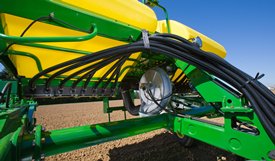 1720 CCS fan and seed delivery hoses
1720 CCS fan and seed delivery hoses

CCS is about reducing the time spent filling the planter with seed while maximizing the time spent planting. CCS for planters is a form of seed handling and delivery. The row-units perform the final task of seed metering and placement.
The CCS seed delivery process relies on a hydraulically driven fan to move seed from the CCS tanks to the row-units. A flow control valve and gauge, located near the tank, allows for the proper tank pressure setting based on seed type.
Air from the fan pressurizes the CCS tanks and delivers seed to the seed hoppers. Air flow enters the seed tanks through a nozzle in the manifold which pressurizes the tank. The air then picks up seed and moves out the other end of the nozzle into the seed delivery hoses. These hoses route the seed toward the hopper. A small amount of seed is traveling in the delivery hoses only when needed.
The hopper fills with seed until the delivery hose (discharge elbow) is covered. Once the opening is restricted, seed flow through the hose stops. Air flowing to the row-unit travels into the hopper and out through a vent. As the seed is picked up by the meter and planted, the seed pool shrinks until the end of the delivery hose is uncovered. At that time, the air flow and seed delivery resume, and the seed pool in the hopper is replenished.
CCS seed cleanout
Seed cleanout could not be easier with a CCS planter. Whether there are 12 or 48 rows, the CCS system and Pro-Series XP™ row-units make quick work of this chore. When the operator is finished planting, any remaining seed can simply be removed via access doors at the bottom of the CCS tank.
Because seed is only traveling through the CCS delivery hoses when required by the meter, there is not much left to clean.
Next, CCS seed delivery hoses are purged with air from the CCS fan, and the excess seed is pushed to the individual meters.
Lastly, the vacuum meter door is opened, and seed is removed with the supplied catch pan.
Small-seed CCS components
 Manifold nozzle and nozzle with cover installed
Manifold nozzle and nozzle with cover installed
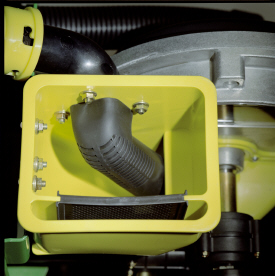 Small-seed elbow installed in mini-hopper
Small-seed elbow installed in mini-hopper
CCS seed delivery system increases planting productivity across the seven approved crops listed above. While highly effective when delivering seed from the CCS tanks to the vacuum meters, small or light seeds (sorghum and small cotton) will require two additional components to aid in proper seed delivery.
Manifold nozzle covers (clips) should be installed to ensure seed is adequately picked up into the air stream for delivery to the row-unit. Mini-hopper discharge elbows should also be changed from the standard elbow (holes) to the small seed elbow (slotted openings) when planting sorghum (milo) and small cotton.
Seed variable-rate drive
1720 Central Commodity System (CCS™) drive system
 Variable-rate drive system
Variable-rate drive system

The seed variable-rate drive on 1720 CCS Planters provides the ultimate planting productivity by utilizing three hydraulic motors to turn the seeding drive shaft. Hydraulic control of the seeding drive allows for on-the-go seeding rate changes right from the display mounted inside the tractor cab. Combine this seeding flexibility with the map-based planting option and seeding rates adjust automatically based on a prescription map.
Seed variable-rate drive requires the SeedStar™ monitoring system and a speed input signal. Either tractor or planter radar may be used or a global positioning system (GPS) speed signal. Radar speed input signal is recommended. Planter radar is ordered separately.
Seed variable-rate drive offers the following advantages:
-
Rate changes are almost instantaneous – no ramp up or ramp down of the system as in some competitive systems
- Permits the operator to match seed population based on different soil types or irrigation practices
- John Deere design provides added operator safety by eliminating any possible drive creep found in some competitive variable-rate drive systems
Three-width drive disconnect
 Three-width drive disconnect control
Three-width drive disconnect control

Three-width drive disconnect is base equipment on the 1720 CCS Planters. This feature is activated by three individual console mounted switches (control box) conveniently located in the tractor cab. The function easily shuts off the planter row-unit seed meters by one-, two- or three-drive segments independently.
RowCommand™ individual-row control system
RowCommand controls seed output
 RowCommand on a MaxEmerge™ 5 row-unit
RowCommand on a MaxEmerge™ 5 row-unit
 RowCommand on a chain drive MaxEmerge 5 row-unit
RowCommand on a chain drive MaxEmerge 5 row-unit
Controlling input costs and improving productivity are key producer requirements today. RowCommand is an effective, integrated John Deere solution designed to meet these intensifying needs. The RowCommand system manages seed output, reduces yield drag, and improves harvest capabilities on all Pro-Shaft™ driven row-units, and chain-driven MaxEmerge 5.
NOTE: Chain-drive RowCommand is only compatible with planters equipped with pneumatic downforce systems. On planters equipped with the heavy-duty downforce springs, potential chain interference may result and is not recommended.
NOTE: Chain-drive RowCommand requires some modification to brackets in order to function with corn finger pickup meters.
NOTE: Pro-Shaft drive RowCommand is compatible on MaxEmerge 5 row-units with vacuum and corn finger pickup meters. For mini-hopper row-units, RowCommand is compatible on vacuum meters only and is not compatible on corn finger pickup meters. Pro-Series™ XP row-units with corn finger pickup meters are not compatible with RowCommand.
RowCommand controls seed output by incorporating individual, low amperage clutches inside the Pro-Shaft and chain-driven gearboxes. Clutches are completely enclosed within the gearbox housing to protect them from the elements and harsh operating conditions.
When power is supplied, either manually or through John Deere Section Control software, clutches disengage the seed meters and seed flow stops. Controlling seed output at individual rows reduces overplanting in point rows and maximizes seed placement when entering/exiting headlands.
Components and operation
 Electronic power modules shown on a 1775NT Planter
Electronic power modules shown on a 1775NT Planter
 RowCommand clutch on MaxEmerge 5 with 105.7-L (3-bu) hopper
RowCommand clutch on MaxEmerge 5 with 105.7-L (3-bu) hopper
RowCommand is a simple and efficient solution to control individual row planting. This system does not utilize air to operate; therefore, no compressor, air lines, or valve modules are required.
RowCommand utilizes low-voltage controller area network (CAN) messaging to signal power to the desired clutches to stop planting or eliminates power to resume planting.
This means very little power is used in normal planting conditions, and in the event a clutch fails electrically, the meter will continue to plant.
The RowCommand system requires the following five basic components to operate:
-
Electric clutches
-
Electronic power modules (EPMs)
-
SeedStar™ 2 monitoring (wedge box/controller)
-
GreenStar™ (GS) display
-
Planter wiring harnesses
Clutches are protected within the sealed Pro-Shaft and chain-driven gearboxes for years of trouble-free operation and simple installation or removal. RowCommand has true individual-row control of up to 16 clutches or sections for planters larger than 16 rows.
Unique to RowCommand, the 16 available control sections can be configured based on operator preferences. For example, on a 1775NT 24-Row Planter, every two rows can be paired together for a total of 12 control sections, or control the outermost eight rows individually and the remaining inner rows paired together for 16 control sections.
While SeedStar with RowCommand has 16 control sections, a minimum of 152.4-cm (60-in.) wide sections are recommended for optimum Swath Control Pro™ solution capabilities. As with other Swath Control Pro products, an SF2 signal is the minimum level of accuracy recommend for operation.
Integrated Swath Control Pro
Coupling RowCommand with Swath Control Pro provides the ultimate in precision planting and productivity. One company, one integrated solution are what we offer by incorporating Swath Control Pro capabilities within the SeedStar 2 wedge box (controller). Unlike previous systems, no rate controller, additional harnessing, or components are required to achieve automated individual-row control.
SeedStar 2 monitoring, RowCommand, and Swath Control Pro activation from John Deere Precision Ag Technologies are all that is needed when ordering.
Pro-Shaft drive RowCommand planters
RowCommand is available as a factory-installed option or as an attachment for field conversion attachments for the following Pro-Shaft drive planter models (see chart below).
| Planter model | Row configuration |
| 1725 | 12-row narrow, 12-row wide, and 16-row narrow |
| 1725 Central Commodity System (CCS™) | 16-row narrow |
| 1765 | 12-row narrow |
| 1775 | 12-row narrow |
| 1775NT | 12 row, 16 row, and 24-row narrow |
| 1775NT CCS | 12 row, 16 row, and 24-row narrow |
| 1795 | 12/23 row, 12/24 row, 16/31 row, and 16/32 row |
| 1795 | 24 row, 50.8 cm (20 in.) |
| DB 44 | 24 row, 55.9 cm (22 in.) |
| DB 58 | 32 row, 55.9 cm (22 in.) |
| DB 60 | 36 row, 50.8 cm (20 in.) or 47 row, 38.1 cm (15 in.) |
| DB 66 | 36 row, 55.9 cm (22 in.) |
| DB 80 | 32 row, 76.2 cm (30 in.) or 48 row, 50.8 cm (20 in.) |
| DB 88 | 48 row, 55.9 cm (22 in.) |
| DB 90 | 36 row, 76.2 cm (30 in.) |
| DB 120 | 48 row, 76.2 cm (30 in.) |
| DR (Deere/Orthman™ planter) 16R40 | 16 row, 101.6 cm (40 in.) |
| DR (Deere/Orthman) 18R38 | 18 row, 96.5 cm (38 in.) |
Chain-drive RowCommand planters
In terms of planter compatibility, RowCommand for chain drive is designed for the following planter model configurations equipped with pneumatic downforce systems.
| Planter model | Row configuration |
| 1725 | 12-row narrow, 12-row wide, and 16-row narrow |
| 1765 | 12-row narrow |
| 1775 | 12-row narrow |
| 1775NT | 12 row and 16 row |
| 1775NT CCS | 12 row and 16 row |
| DB 44 | 24 row, 55.9 cm (22 in.) |
Chain-drive RowCommand and heavy-duty downforce
 Chain interference with heavy-duty downforce
Chain interference with heavy-duty downforce
As seen in the image, chain interference may result when operating chain-drive RowCommand on planters equipped with short and long parallel arms and heavy-duty downforce springs.
NOTE: Chain-drive RowCommand is only compatible with planters equipped with pneumatic downforce systems. On planters equipped with the heavy-duty downforce springs, potential chain interference may result and is not recommended.
Chain-drive RowCommand with corn finger pickup meters
 Bracket material removal
Bracket material removal
Due to the design characteristics of the chain-drive RowCommand clutch, some modification to the corn finger pickup meter drive bracket is required. As seen in the picture to the left, some material needs to be removed from the front of the meter drive bracket in order for the chain-drive RowCommand clutch to have sufficient space for installation.
NOTE: Chain-drive RowCommand requires some modification to brackets in order to function with corn finger pickup meters.
RowCommand ordering information
To add RowCommand to a model year 2009 and newer planter model listed above is simple. Pro-Shaft drive attachments for field conversion and chain-drive attachments for field conversion are available by planter model to add the appropriate number of clutches, EPMs, brackets, hardware and row-unit harnesses. For complete installation and part detail for the RowCommand conversion, please use the RowCommand compatibility tool per specific planter model.
RowCommand is compatible and available for model year 2003 (serial number 700101) to 2008 (725101) planter models listed above. In addition to the attachment for field conversion attachment, a planter mainframe harness, SeedStar 2 controller (wedge box), and additional CAN harnesses are needed.
System requirements
RowCommand is a simple and efficient means to control individual row planting through the use of low-voltage electric clutches. When activated, each clutch consumes no more than 0.5 amps. By design, power is only supplied to the clutch when a signal is received to stop planting. In a normal planting condition, no power is supplied and the clutch is de-energized.
Power for the RowCommand system is provided from the 9-pin ISO implement connector. All late-model 8X00 and 9X00 Series John Deere Tractors equipped with the 9-pin ISO implement connector are capable of supplying ample power for system operation.
Along with ample system power, a GreenStar display and SeedStar monitoring are required for operation and control interface. The GreenStar display is where system setup, control settings, and manual control functions are performed.
Lift-assist wheel steering
Hydraulic steering for chassis lift system
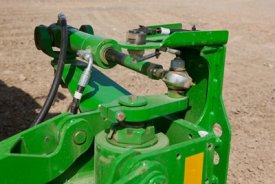 Hydraulic steering cylinder
Hydraulic steering cylinder
 Position sensor
Position sensor
The hydraulic steering assists the operator while backing into the next pass. The implement wheels are steered in the opposite direction of the tractor steering wheels when in reverse. The system is calibrated to steer the lift-assist wheels to the ideal steering angle when turning in reverse and guides the planter from a position sensor mounted to the tractor's front axle.
This steering system prevents the lift-assist wheels from casting or spinning around when the direction is changed from forward to reserve. This saves disruption to beds or soil. The hydraulic steering also provides resistance to lift-assist wheels, eliminating vibrations from the wheels while traveling forward, and is most beneficial during transport.
Less hydraulic steering for chassis lift system
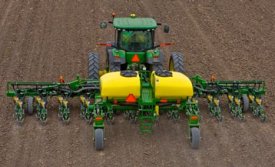 Less hydraulic steering
Less hydraulic steering

Less lift-assist wheel steering is available to producers who do not need to guide the lift-assist wheels in reverse. This eliminates the need for the position sensor mounted the tractor’s front axle. The less hydraulic steering option does not provide resistance to vibrations from the lift-assist wheels during transport and allows the wheels to caster or spin around during direction changes.
Features
RowCommand™ individual-row control system
RowCommand controls seed output
 RowCommand on a MaxEmerge™ 5 row-unit
RowCommand on a MaxEmerge™ 5 row-unit
 RowCommand on a chain drive MaxEmerge 5 row-unit
RowCommand on a chain drive MaxEmerge 5 row-unit
Controlling input costs and improving productivity are key producer requirements today. RowCommand is an effective, integrated John Deere solution designed to meet these intensifying needs. The RowCommand system manages seed output, reduces yield drag, and improves harvest capabilities on all Pro-Shaft™ driven row-units, and chain-driven MaxEmerge 5.
NOTE: Chain-drive RowCommand is only compatible with planters equipped with pneumatic downforce systems. On planters equipped with the heavy-duty downforce springs, potential chain interference may result and is not recommended.
NOTE: Chain-drive RowCommand requires some modification to brackets in order to function with corn finger pickup meters.
NOTE: Pro-Shaft drive RowCommand is compatible on MaxEmerge 5 row-units with vacuum and corn finger pickup meters. For mini-hopper row-units, RowCommand is compatible on vacuum meters only and is not compatible on corn finger pickup meters. Pro-Series™ XP row-units with corn finger pickup meters are not compatible with RowCommand.
RowCommand controls seed output by incorporating individual, low amperage clutches inside the Pro-Shaft and chain-driven gearboxes. Clutches are completely enclosed within the gearbox housing to protect them from the elements and harsh operating conditions.
When power is supplied, either manually or through John Deere Section Control software, clutches disengage the seed meters and seed flow stops. Controlling seed output at individual rows reduces overplanting in point rows and maximizes seed placement when entering/exiting headlands.
Components and operation
 Electronic power modules shown on a 1775NT Planter
Electronic power modules shown on a 1775NT Planter
 RowCommand clutch on MaxEmerge 5 with 105.7-L (3-bu) hopper
RowCommand clutch on MaxEmerge 5 with 105.7-L (3-bu) hopper
RowCommand is a simple and efficient solution to control individual row planting. This system does not utilize air to operate; therefore, no compressor, air lines, or valve modules are required.
RowCommand utilizes low-voltage controller area network (CAN) messaging to signal power to the desired clutches to stop planting or eliminates power to resume planting.
This means very little power is used in normal planting conditions, and in the event a clutch fails electrically, the meter will continue to plant.
The RowCommand system requires the following five basic components to operate:
-
Electric clutches
-
Electronic power modules (EPMs)
-
SeedStar™ 2 monitoring (wedge box/controller)
-
GreenStar™ (GS) display
-
Planter wiring harnesses
Clutches are protected within the sealed Pro-Shaft and chain-driven gearboxes for years of trouble-free operation and simple installation or removal. RowCommand has true individual-row control of up to 16 clutches or sections for planters larger than 16 rows.
Unique to RowCommand, the 16 available control sections can be configured based on operator preferences. For example, on a 1775NT 24-Row Planter, every two rows can be paired together for a total of 12 control sections, or control the outermost eight rows individually and the remaining inner rows paired together for 16 control sections.
While SeedStar with RowCommand has 16 control sections, a minimum of 152.4-cm (60-in.) wide sections are recommended for optimum Swath Control Pro™ solution capabilities. As with other Swath Control Pro products, an SF2 signal is the minimum level of accuracy recommend for operation.
Pro-Shaft drive RowCommand planters
RowCommand is available as a factory-installed option or as an attachment for field conversion attachments for the following Pro-Shaft drive planter models (see chart below).
| Planter model | Row configuration |
| 1725 | 12-row narrow, 12-row wide, and 16-row narrow |
| 1725 Central Commodity System (CCS™) | 16-row narrow |
| 1765 | 12-row narrow |
| 1775 | 12-row narrow |
| 1775NT | 12 row, 16 row, and 24-row narrow |
| 1775NT CCS | 12 row, 16 row, and 24-row narrow |
| 1795 | 12/23 row, 12/24 row, 16/31 row, and 16/32 row |
| 1795 | 24 row, 50.8 cm (20 in.) |
| DB 44 | 24 row, 55.9 cm (22 in.) |
| DB 58 | 32 row, 55.9 cm (22 in.) |
| DB 60 | 36 row, 50.8 cm (20 in.) or 47 row, 38.1 cm (15 in.) |
| DB 66 | 36 row, 55.9 cm (22 in.) |
| DB 80 | 32 row, 76.2 cm (30 in.) or 48 row, 50.8 cm (20 in.) |
| DB 88 | 48 row, 55.9 cm (22 in.) |
| DB 90 | 36 row, 76.2 cm (30 in.) |
| DB 120 | 48 row, 76.2 cm (30 in.) |
| DR (Deere/Orthman™ planter) 16R40 | 16 row, 101.6 cm (40 in.) |
| DR (Deere/Orthman) 18R38 | 18 row, 96.5 cm (38 in.) |
Chain-drive RowCommand planters
In terms of planter compatibility, RowCommand for chain drive is designed for the following planter model configurations equipped with pneumatic downforce systems.
| Planter model | Row configuration |
| 1725 | 12-row narrow, 12-row wide, and 16-row narrow |
| 1765 | 12-row narrow |
| 1775 | 12-row narrow |
| 1775NT | 12 row and 16 row |
| 1775NT CCS | 12 row and 16 row |
| DB 44 | 24 row, 55.9 cm (22 in.) |
Chain-drive RowCommand and heavy-duty downforce
 Chain interference with heavy-duty downforce
Chain interference with heavy-duty downforce
As seen in the image, chain interference may result when operating chain-drive RowCommand on planters equipped with short and long parallel arms and heavy-duty downforce springs.
NOTE: Chain-drive RowCommand is only compatible with planters equipped with pneumatic downforce systems. On planters equipped with the heavy-duty downforce springs, potential chain interference may result and is not recommended.
Chain-drive RowCommand with corn finger pickup meters
 Bracket material removal
Bracket material removal
Due to the design characteristics of the chain-drive RowCommand clutch, some modification to the corn finger pickup meter drive bracket is required. As seen in the picture to the left, some material needs to be removed from the front of the meter drive bracket in order for the chain-drive RowCommand clutch to have sufficient space for installation.
NOTE: Chain-drive RowCommand requires some modification to brackets in order to function with corn finger pickup meters.
RowCommand ordering information
To add RowCommand to a model year 2009 and newer planter model listed above is simple. Pro-Shaft drive attachments for field conversion and chain-drive attachments for field conversion are available by planter model to add the appropriate number of clutches, EPMs, brackets, hardware and row-unit harnesses. For complete installation and part detail for the RowCommand conversion, please use the RowCommand compatibility tool per specific planter model.
RowCommand is compatible and available for model year 2003 (serial number 700101) to 2008 (725101) planter models listed above. In addition to the attachment for field conversion attachment, a planter mainframe harness, SeedStar 2 controller (wedge box), and additional CAN harnesses are needed.
Integrated Swath Control Pro
Coupling RowCommand with Swath Control Pro provides the ultimate in precision planting and productivity. One company, one integrated solution are what we offer by incorporating Swath Control Pro capabilities within the SeedStar 2 wedge box (controller). Unlike previous systems, no rate controller, additional harnessing, or components are required to achieve automated individual-row control.
SeedStar 2 monitoring, RowCommand, and Swath Control Pro activation from John Deere Precision Ag Technologies are all that is needed when ordering.
System requirements
RowCommand is a simple and efficient means to control individual row planting through the use of low-voltage electric clutches. When activated, each clutch consumes no more than 0.5 amps. By design, power is only supplied to the clutch when a signal is received to stop planting. In a normal planting condition, no power is supplied and the clutch is de-energized.
Power for the RowCommand system is provided from the 9-pin ISO implement connector. All late-model 8X00 and 9X00 Series John Deere Tractors equipped with the 9-pin ISO implement connector are capable of supplying ample power for system operation.
Along with ample system power, a GreenStar display and SeedStar monitoring are required for operation and control interface. The GreenStar display is where system setup, control settings, and manual control functions are performed.
SeedStar™ 2 monitoring system
Integrated innovation is what operators will appreciate with the SeedStar 2 monitoring system and GreenStar™ 2 Display. An increasing number of acres combined with rising seed costs drive the need to easily understand planter functions and monitor performance. It is all about making every seed count and that is what SeedStar 2 delivers.
The SeedStar 2 monitoring system is a full-feature, color, seed population monitor used in conjunction with the GreenStar family of displays. SeedStar 2 is compatible with the GreenStar 2 1800 and 2600 Displays, GreenStar 3 2630 Display, the Gen 4 4200 CommandCenter™ Display, the Gen 4 4600 CommandCenter Display, the 4240 Universal Display, and the 4640 Universal Display. SeedStar 2 is not compatible with the Gen 4 Extended Monitor. Conveniently, SeedStar 2 planting functions are fully integrated with the full spectrum of Precision Ag Technology applications—guidance, coverage maps, and field documentation can be shown all on one display.
When a SeedStar 2 system is used on a planter, there is no need for a ComputerTrak™ monitor. All vital planting information is displayed in one central, easy-to-read location.
SeedStar 2 features
 SeedStar 2 full-screen planter run page
SeedStar 2 full-screen planter run page
SeedStar 2 is a user-friendly system that has retained all the valued features of SeedStar and incorporated the next generation of enhancements. For example, on-screen color indicators show drive engagement/disengagement status. In addition, three color planter-at-a-glance bars (black, orange, or red) visually inform the operator of row population status.
Not only does SeedStar 2 incorporate the use of color, it also utilizes an intuitive icon and folder based operator interface. Icons are easy to understand across many languages and reduce the need for text. Icons for planter main run page, planter setup, seed/crop setup, totals, and diagnostics are located in the soft-key region of the display. Setup is performed by selecting the appropriate icon and then choosing the tabs to enter/select information.
The SeedStar 2 monitor offers all of the features and functionality of the ComputerTrak 350 monitor and much more. SeedStar 2 monitors the following planter functions:
- Row population/spacing
- Row failure
- Average population (entire planter and by variable-rate drive [VRD] motor section)
- Vacuum level
- Fertilizer pressure
- Acre counter
- Total acreage
- Tractor speed
In addition, planter operational information is available within the SeedStar 2 monitor system. Such operational information includes population charts, seed disk vacuum settings, and setting recommendations for the piston pump liquid fertilizer system.
All SeedStar 2 systems have the capability, through a single controller, to perform both the seed monitoring and variable rate drive functions. SeedStar 2 monitoring is required for VRD population control. Even though the planter may not be equipped with SeedStar 2 VRD, the SeedStar 2 monitoring system is available and will allow for future installation of VRD.
SeedStar 2 enhancements
 SeedStar 2 half-screen planter run page
SeedStar 2 half-screen planter run page
 SeedStar 2 showing half-width disconnect status
SeedStar 2 showing half-width disconnect status
The SeedStar 2 enhanced planter features include:
- GreenStar 2 display integration – eliminates the need to operate the GreenStar 2 2600 Display in the original GreenStar monitor mode or the use of dual displays.
- User-friendly, intuitive icons
- Half- or full-screen run page
- On-screen, color drive status – a quick glance at the display tells the operator if the half-width disconnect is engaged or disengaged.
- Three-color planter-at-a-glance population bar – a black bar indicates that population is close to target and within established limits; orange shows the population is above/below the alarm set point; and red signals the population is out of operating range or is not planting.
- Three-piece, color VRD indicator – each piece of the VRD gear pie turns green when the wheel motion sensor is active, planter is lowered, and drives are engaged.
SeedStar monitoring original features
SeedStar 2 retains all those SeedStar features that producers value and have come to expect:
-
Planter at a glance – allows operator to view relative population levels of all rows on one screen.
-
Automatic valve calibration – with the SeedStar VRD, this is now completed automatically. There is no longer a need to manually calibrate the hydraulic valves.
-
Increased population updates – SeedStar will now update population levels once a second at planter start up then approximately once every three seconds.
-
Mapping of actual seed rates – When combined with Field Doc™ system, actual and target seeding rates can now be mapped in APEX™ software.
-
Reprogrammable utilizing controller area network (CAN) via Service ADVISOR™ diagnostics system.
-
Improved diagnostics/event recorder – on SeedStar VRD planters, additional diagnostic information is available, as well as an event recorder to capture system performance data at a specific point in time.
-
Ability to run motors at different population levels – on SeedStar VRD, operators running multiple motor systems can run each motor at a different speed, allowing different population levels within a planter.
-
User-configurable high fertilizer pressure alarm – allows the operator to be warned when fertilizer pressure reaches a specific level.
-
Automatic quick-start for SeedStar VRD – the operator no longer needs to press the quick-start button on end row turns to resume planting.
-
Automatic tractor speed source selection – when equipped with an 8000/9000 Series Tractor, the system selects the radar speed or allows for manual speed input selection.
Pneumatic downforce system
Pneumatic downforce provides convenient, simple adjustment of downforce for the whole planter from one location. The amount of downforce applied is infinitely adjustable from 0 kg to 181.4 kg (0 lb to 400 lb). Pneumatic downforce provides more consistent downforce throughout the range of row-unit travel than mechanical spring downforce systems.
Several pneumatic downforce system improvements have been implemented, including:
- 9.5-mm (3/8-in.) air delivery line instead of the 6.4-mm (1/4-in.) line used on model year 2010 and older planters.
- Air compressor assembly increased duty cycle. With this compressor, it provides a 47 percent increase in maximum air flow delivery compared to the prior air compressor.
- Pneumatic air bags with 9.5-mm (3/8-in.) air line inlets that have greater durability.
Such improvements to the pneumatic downforce system enable faster and more precise control of row-unit downforce while planting.
System features
 Pneumatic downforce spring
Pneumatic downforce spring

Each row-unit has a single, rubber air bag located between the parallel arms. The air bags are hooked in parallel so that air can be added or released from all rows at once from one location.
Pneumatic downforce systems are available as base equipment on all 1700 Series and DB Planters. The individual pneumatic downforce air bag assemblies, air compressor units, and 9.5-mm (3/8-in.) delivery lines are also available as an attachment for field conversion.
 Pneumatic downforce compressor and gauge
Pneumatic downforce compressor and gauge

An improved compressor is used to charge the pneumatic system. This compressor can be located on the planter frame or in the tractor cab if desired. A gauge at the compressor indicates the amount of downforce being applied.
From the factory, integral planter models with pneumatic downforce will have an improved air compressor assembly with an in-cab mounting bracket, except the 1725 16Row and 1725 Central Commodity System (CCS™) Twin-Row Planters which will have the air compressor assembly mounted on the planter frame. For drawn planter models, the 1755, 1765, 1765NT, 1775 Front-Fold, and 1785 Drawn Planters will have the air compressor assembly installed either on the outer hitch or wing frame members when the pneumatic downforce system is installed.
Row cleaner options to meet residue management needs
Crop yields have increased through the years along with the amount of residue left in the field after harvest. At the same time, tillage practices have changed, including different tillage operations which maintain large amounts of surface residue, and even no-till practices. Row cleaners are an essential tool in managing this increased amount of residue.
John Deere seeding group offers a variety of row cleaner options to meet the needs of a producer's operation. Compatibility varies by model, row spacing, and other planter equipment.
Screw-adjust, unit-mounted row cleaner
 Screw-adjust, unit-mounted row cleaner
Screw-adjust, unit-mounted row cleaner
The screw-adjust, unit-mounted row cleaner is mounted directly to the face plate of the row-unit, placing the ground engaging components just in front of the row-unit opener blades and depth gauge wheels. This close proximity allows the gauge wheels to control the depth of the row cleaner as well as the row-unit. This compact design also allows greater compatibility with fertilizer openers and other planter attachments.
SharkTooth® wheels are standard equipment on the unit-mounted row cleaner. The swept-tooth design of the wheel provides a clear path for the row-unit openers while resisting residue buildup on the wheel. The screw adjustment knob is accessible through the top of the parallel arms, providing convenient access for adjustments. The row cleaner can be adjusted in 1.6-mm (1/16-in.) increments, providing plenty of flexibility to meet the needs of changing conditions.
Floating row cleaner with unit-mounted coulter
 Floating row cleaner with unit-mounted coulter
Floating row cleaner with unit-mounted coulter
The floating row cleaner allows a row cleaner to be used in conjunction with a unit-mounted coulter. This combination is often desired in heavy residue loads and reduced tillage planting conditions. The row cleaner provides a clear path for the row-unit, while the unit-mounted coulter helps penetrate tough soil conditions.
Accommodating the unit-mounted coulter means the residue wheels are farther forward from the row-unit face plate than in the case of the screw-adjust row cleaner. To maintain performance, this row cleaner has the capability to float above a defined minimum depth.
Standard depth-gauging bands on the wheels allow the row cleaner wheels to float independently of the row-unit openers, allowing both to perform in varying terrain. The unit may also be set in a fixed position by simply pinning through the bracket if desired. This row cleaner also features SharkTooth wheels as standard equipment.
The floating row cleaner and unit-mounted coulters are available on many planters as factory-installed equipment. As compatibility and details vary by model, review the following links for information on specific planter models.
NOTE: Screw-adjust row cleaners are not compatible with MaxEmerge™ 5e row-units with long parallel arms.
NOTE: DB models have the option for either unit-mounted coulter, screw-adjust row cleaners, or pneumatic row cleaners (only compatabile with MaxEmerge 5e or equipped ExactEmerge™ models). The DB60T is only available with a less row cleaner option.
SharkTooth is a trademark of Yetter Manufacturing, Inc.
Seed variable-rate drive
Seed variable-rate drive provides the ultimate planting productivity by utilizing one, two, or three hydraulic motors (varies by model) to turn the seeding drive shaft. Hydraulic control of the seeding drive allows for on-the-go seeding rate changes right from the display mounted inside the tractor cab. Combine this seeding flexibility with the map-based planting option, and seeding rates adjust automatically based on the prescribed map.
Variable-rate drive offers the following advantages over common, ground, or contact-tire drive systems:
-
Rate changes are almost instantaneous; no ramp up or ramp down of system as in some competitive systems
- Permits the producer to match seed population based on different soil types or irrigation practices
- John Deere design provides added operator safety by eliminating any possible drive creep found in some competitive variable-rate drive systems
 1755 equipped with variable-rate drive
1755 equipped with variable-rate drive
 1765NT equipped with variable-rate drive
1765NT equipped with variable-rate drive
Single- or dual-motor systems for variable-rate drives are available for all John Deere planters except the 1785 Rigid Frame. Variable-rate drive is available as a factory-installed option for all applicable planter models.
Single- or dual-motor systems are available as field-installed attachments for most planter models; however, a three-motor variable-rate drive field-installed attachment is not available.
Seed variable-rate drive requires the SeedStar™ monitor and a radar input signal. Either tractor or planter radar may be used. Planter radar is ordered separately.
NOTE: Peanut seed meter disks require the variable-drive transmission.
MaxEmerge™ 5 row-unit
 MaxEmerge 5 with 56-L (1.6-bu) hopper plus insecticide
MaxEmerge 5 with 56-L (1.6-bu) hopper plus insecticide
 MaxEmerge 5 with mini-hopper on Central Commodity System (CCS™) machines only
MaxEmerge 5 with mini-hopper on Central Commodity System (CCS™) machines only
The MaxEmerge family of row-units have never seen a more versatile and efficient design until the MaxEmerge 5. The 5-family row-units improve productivity, increase uptime and lower the cost of ownership like never before.
The MaxEmerge 5 row-unit was designed for improved performance and serviceability.


Serviceability and changing crops has always been a focus of downtime and potential seed loss. MaxEmerge XP row-units (shown on the left) are designed with the meter and hopper as one component. The frame covers the meter so that it cannot be accessed. Cleanout of excess seed requires the operator to take the entire hopper off of the row-unit and to turn it upside down. The MaxEmerge 5 meter (shown on the right) is accessible without having to remove the box. The MaxEmerge 5 design allows large hoppers to be cleaned out the same as mini-hoppers, simply by opening the meter dome and catching the seed as it falls out. This improvement allows operators to change seed varieties easier and three times faster than it took them on the previous MaxEmerge XP units and provides more uptime during the tight planting window.
 MaxEmerge 5 vacuum seed meter
MaxEmerge 5 vacuum seed meter
The vacuum meter system gently pulls and holds individual seeds to the holes of the seed disk for population control and spacing accuracy, equaling better crop stands and profit. Vacuum seed meters can plant a wide variety of crops and seed types by simply changing seed disks and adjusting vacuum level. Vacuum seed meters are available for planters with MaxEmerge 5 row-units.
Additional features of the vacuum seed meter include:
- One moving component (the seed metering disk) for minimum maintenance requirements
- Meter located at each row-unit for accurate seed delivery
- Good hopper seed flow characteristics for longer operating time per hopper fill
- Low airflow in meter so seed treatments are not removed
 Pro-Series™ row-unit seed pool
Pro-Series™ row-unit seed pool
 MaxEmerge 5 seed pool
MaxEmerge 5 seed pool
The MaxEmerge 5 meter shape has also been redesigned for better seed flow. The mini-hopper design allows the planter to successfully operate on side hills up to 14 degrees.
Vacuum meter hub and latching handle
 MaxEmerge 5 vacuum meter with disk
MaxEmerge 5 vacuum meter with disk
Both the MaxEmerge 5 vacuum meters are equipped with a heavy-duty hub spring and disk latching handle. The spring ensures the seed disk stays properly positioned when operating flat-style seed disks and higher vacuum levels. Proper seed disk positioning means repeatable seed singulation, time after time. The disk-latching handle is designed for easy operation and effortless seed disk changeover. The hub is also machined to tight tolerances to further ensure alignment of metering components.
 Flat-style and cell seed disks shown
Flat-style and cell seed disks shown
The unique cell disk design allows planting a variety of seed sizes without any additional parts or individual meter adjustments. Another advantage of cell-type seed disks is the lower vacuum requirement compared to flat-style seed disks. Lower vacuum levels mean less hydraulic demand from the tractor. Most planting conditions call for a flat disk, if you are limited in hydraulic capacity, cell disks are recommended.
Operating characteristics of vacuum seed meter
 Operating speed with seed tube technology
Operating speed with seed tube technology
The vacuum seed meter is capable of operating at faster planting speeds than mechanical meters. However, planting accuracy will be influenced by seedbed conditions and the operating characteristics of the seed meter. Rough seedbeds and fast planting speeds (above 8.9 km/h [5.5 mph]) typically deteriorate seed placement accuracies when using seed tube technology.
The chart illustrates the effect operating speed has on population when using the vacuum meter. The operating band (color area) illustrates how the vacuum meter performs in relation to the desired population (indicated by horizontal line). The width of the band is due to various sizes and shapes of seeds and planting rate variations.
When operating on slopes above 15 degrees, increased or decreased population may result. To minimize this effect, reduce speed and consider using a flat style seed disk with increased vacuum level.
Vacuum meter seed disks
The ProMax 40 Flat Disk is a flat-disk planting solution field-proven to work since 1991.

The design of the ProMax 40 Flat Disk position allows seed to be released from the optimum position above the seed tube. The flush-face seed tube allows the seed to drop uninterrupted through the tube.
The ProMax 40 Flat Disk utilizes flat holes and a higher vacuum level to ensure every hole is populated with a seed. A double eliminator gently removes multiple seeds at each hole for precise population control. A knockout wheel makes certain that each hole is clear of any debris after the seed is released from the disk.
Double eliminator

For difficult to singulate seeds, a flat seed disk and double eliminator is a viable alternative to traditional cell-type seed disks. By design, a flat seed disk requires higher levels of vacuum than a cell-type disk because there is no pocket or cell to hold the seed. The higher vacuum level will pull more than one seed to the holes in the seed disk. The double eliminator is set to cover a portion of the hole in the seed disk and is the mechanism to knock multiple seeds away as the disk rotates.
Double eliminators are required with flat-type seed disks only and should not be used with cell-type seed disks. The knockout wheel is also recommended in conjunction with the double eliminator and flat seed disk to ensure seed is ejected from the disk.
Flat and celled type seed metering disks are available to allow planting a wide variety of seed types.
- Corn (field, popcorn, or sweet corn)
- Soybeans
- Cotton
- Sorghum
- Sugar beets
- Sunflowers
- Edible beans/peas
- Peanuts
- Melons, squash, cucumbers
Mini-hopper row-units, which are used only with the CCS, are compatible only with crops that the CCS is approved to plant.
- Corn
- Popcorn
- Sweet corn
- Soybeans
- Sunflowers
- Sorghum
- Cotton
NOTE: Due to small seed size and low planting populations, sugar beets can be planted with mini-hopper style meters by adding hopper extensions and not using the CCS tank. These hopper extensions can also be used for planting test plots.
 Hopper shutoff
Hopper shutoff

Also, to help with meter access of 56-L and 106-L (1.6-bu and 3-bu) hoppers the hopper shutoff feature was added. With the shutoff engaged, the meter cover can be opened without first having to remove all of the seeds from the hopper. Lever down, the seed flow is on, lever horizontal and the seed flow is off.
 MaxEmerge 5 mini-hopper
MaxEmerge 5 mini-hopper

There are significant changes to the MaxEmerge 5 mini-hopper. One update is the straight feed from the CCS hose to the mini-hopper to ensure a continuous free flow of seeds. This design change reduces the potential for plugging issues with larger seed size and the use of seed treatments. By drawing air from the CCS tank, the vacuum source is cleaner, preventing meter debris buildup.
 Ductile iron-cast shank
Ductile iron-cast shank

Ductile iron casting is a unique high-tech process that produces a single-piece row-unit shank this enables alignment from the seed trench to the closing wheel.
The row-unit head is also designed using the ductile iron-casting process. The row-unit head provides the mating joints between the row-unit parallel arms and the row-unit shank. It is also the upper attaching point for the seed meter and seed hopper.
Ductile iron casting of the row-unit shank and head assembly provides a row-unit that is 25 percent stronger than other competitive welded row-units.
 Rubber tire closing system
Rubber tire closing system
 Cast wheel closing system
Cast wheel closing system
Rubber tire closing systems are used for most conventional, minimum-till, and no-till planting conditions. The spacing between the wheels is adjustable so the closing system can meet the needs of those who want to plant small seeds at shallow depths.
The wheels can also be staggered fore and aft to enhance residue flow. Four levels of spring force are available and are easily set with the integrated T-handle adjustment. A lower force spring can be obtained from parts, if a lower amount of force is required.
Additional closing wheel options include:
- Cast closing wheels, for tough-to-close conditions
- Disk closing, for shallow planting depths
- Closing wheel frame less wheels, for growers desiring to use aftermarket closing wheels

One of the trademark capabilities of John Deere planters has always been the ability of the Tru-Vee openers to provide an ideal seed furrow.
The thickness of the Tru-Vee opener blade is 3.5 mm (0.14 in.) this blade thickness will provide extended wear life.
The MaxEmerge 5 row-unit also provides better Tru-Vee opener bearings for longer life. The double-row ball bearing provides up to three times the wear life as the single-row bearing.
 Depth adjustment T-handle
Depth adjustment T-handle

John Deere planters provide consistent seed depth control in all field conditions. Depth control is a function of the Tru-Vee openers, the downforce system, and the gauge wheel assembly.
The gauge wheel itself is made of durable nylon composition with a concave profile. This profile gently firms the sides of the seed furrow, ensuring a well-defined trench. The shape reduces rocks and residue being picked up and thrown onto the drive chains and row-units, and helps to prevent rooster tailing of soil.
The bolt-through design utilizes an open bearing in the gauge wheel that allows an attaching bolt to pass through the wheel to the threaded hole in the gauge wheel arm. This simple bolt-through design provides for a positive attachment of the gauge wheel to the gauge wheel arm and allows quick removal of the gauge wheel for service.
Adjustability of the row-unit is critical to good performance. More available downforce options than any row unit in the industry
- Adjustable heavy-duty downforce, four settings, 0 kg (0 lb), 57 kg (125 lb), 113 kg (250 lb), and 181 kg (400 lb) of downforce
- Pneumatic downforce, infinitely variable from 0 to 181 kg (0 to 400 lb) of downforce
- Active pneumatic downforce adjusts automatically for changing ground conditions from 0 to 181 kg (0 to 400 lb) of downforce
1725 Central Commodity System (CCS™) Planter - integral stack folding
Convenient stack-folding design combined with rigid or flexible frame
 1725 CCS 16Row30 Stack-Fold Planter with ExactEmerge™ row-unit
1725 CCS 16Row30 Stack-Fold Planter with ExactEmerge™ row-unit

The 1725 stack-fold design provides narrow transport capability for these integral, large-frame planters. 1725 Stack-Fold Planters have the ability to operate in both rigid-frame and flex-frame configurations. The 1725 CCS utilizes a three-section frame that can flex up to 10 degrees up and 7 degrees down.
The 1725 CCS Stack-Fold Integral Planter is available in the following configuration: 16Row30 and 12x2 T.
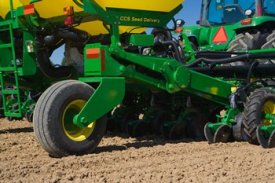 1725 CCS lift-assist wheels
1725 CCS lift-assist wheels

Heavy-duty lift-assist wheels are integrated into the 1725 CCS frame design. The CCS cradle is supported by the heavy-duty lift-assist wheels which reduce the amount of weight placed on the rear of the tractor. This design provides a balanced planter for maneuverability in the field and during transport. The 1725T CCS has larger 16.5L-16.1SL lift-assist wheel tires to provide additional floatation in a variety of soils.
Hydraulic steering is available on the 1725T Planter to guide the planter when the tractor is in reverse. This is useful during headland turns to keep the lift-assist wheels from castering or spinning around while backing to the next pass.
1725 CCS 16Row30 with ExactEmerge planter additional frame features
 Vacuum run through the frame provides multiple benefits
Vacuum run through the frame provides multiple benefits
The vacuum is run through the planter frame rather than the black conduit on top of the frame. This provides many benefits to operators. The frame is cleaner and provides improved visibility when seated in the cab. The frame vacuum lines give increased durability for optimal vacuum performance.
Performance
 Hydraulic cylinder on 1725 CCS 16Row30 frame for wing downforce
Hydraulic cylinder on 1725 CCS 16Row30 frame for wing downforce
Wing downforce has been added to the 1725 CCS 16Row30 with ExactEmerge. When traveling above speeds of 8.05 km/h (5 mph), the wings become lighter, sacrificing ride quality and consistent depth. Hydraulic cylinders have been added that transfer weight from the centerframe to the outside wings to maintain consistent weight distribution and provide operators with their desired depth control.
Uptime
 Hydraulic locking mechanism for in-cab wing locking
Hydraulic locking mechanism for in-cab wing locking
An automatic hydraulic wing locking feature is available on the 1725 CCS Planter. Once the operator engages the frame-fold selective control valve (SCV), the hydraulics release the locking mechanism and the planter starts folding. This reduces trips up and down the tractor and provides for a much quicker process in and out of the field.
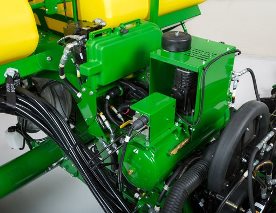 Active pneumatic downforce compressor and ExactEmerge alternator located in front of CCS tanks
Active pneumatic downforce compressor and ExactEmerge alternator located in front of CCS tanks
Active pneumatic downforce is offered in conjunction with the ExactEmerge option codes on the 1725 CCS 16Row30 model. This provides the proven solution for growers to maintain consistent depth even at speeds up to 16.1 km/h (10 mph). See the active pneumatic downforce page for more information.
Central Commodity System (CCS™)
 1720 CCS with 3523.9 L (100 bu) of seed capacity
1720 CCS with 3523.9 L (100 bu) of seed capacity

Central Commodity System (CCS) seed delivery adds productivity through increased seed capacity, bulk-fill capability, and easy, thorough cleanout. The two tanks have a combined capacity of 3523.9 L (100 bu) on the 1720 CCS Planters.
The 1720 CCS Planters have been designed to allow for a convenient central filling location and easy cleanout. The rear entry ladder provides access to the filling platform between the tanks.
For those who work into the night, a fill light package is standard on machines equipped with CCS.
If the seed-carrying vehicle requires hydraulic power to run the unloading system, the auxiliary hydraulic coupler option can be ordered. These couplers are located at the bottom of the staircase and can be coupled under pressure. The system has a separate system filter that ensures the planter's hydraulic system remains free of contaminates.
The following crops can be planted with CCS: corn, sweet corn, popcorn, cotton, sunflowers, soybeans, and sorghum (milo).
 1720 CCS fan and seed delivery hoses
1720 CCS fan and seed delivery hoses

CCS is about reducing the time spent filling the planter with seed while maximizing the time spent planting. CCS for planters is a form of seed handling and delivery. The row-units perform the final task of seed metering and placement.
The CCS seed delivery process relies on a hydraulically driven fan to move seed from the CCS tanks to the row-units. A flow control valve and gauge, located near the tank, allows for the proper tank pressure setting based on seed type.
Air from the fan pressurizes the CCS tanks and delivers seed to the seed hoppers. Air flow enters the seed tanks through a nozzle in the manifold which pressurizes the tank. The air then picks up seed and moves out the other end of the nozzle into the seed delivery hoses. These hoses route the seed toward the hopper. A small amount of seed is traveling in the delivery hoses only when needed.
The hopper fills with seed until the delivery hose (discharge elbow) is covered. Once the opening is restricted, seed flow through the hose stops. Air flowing to the row-unit travels into the hopper and out through a vent. As the seed is picked up by the meter and planted, the seed pool shrinks until the end of the delivery hose is uncovered. At that time, the air flow and seed delivery resume, and the seed pool in the hopper is replenished.
CCS seed cleanout
Seed cleanout could not be easier with a CCS planter. Whether there are 12 or 48 rows, the CCS system and Pro-Series XP™ row-units make quick work of this chore. When the operator is finished planting, any remaining seed can simply be removed via access doors at the bottom of the CCS tank.
Because seed is only traveling through the CCS delivery hoses when required by the meter, there is not much left to clean.
Next, CCS seed delivery hoses are purged with air from the CCS fan, and the excess seed is pushed to the individual meters.
Lastly, the vacuum meter door is opened, and seed is removed with the supplied catch pan.
Small-seed CCS components
 Manifold nozzle and nozzle with cover installed
Manifold nozzle and nozzle with cover installed
 Small-seed elbow installed in mini-hopper
Small-seed elbow installed in mini-hopper
CCS seed delivery system increases planting productivity across the seven approved crops listed above. While highly effective when delivering seed from the CCS tanks to the vacuum meters, small or light seeds (sorghum and small cotton) will require two additional components to aid in proper seed delivery.
Manifold nozzle covers (clips) should be installed to ensure seed is adequately picked up into the air stream for delivery to the row-unit. Mini-hopper discharge elbows should also be changed from the standard elbow (holes) to the small seed elbow (slotted openings) when planting sorghum (milo) and small cotton.
Vacuum automation
 Vacuum automation screen
Vacuum automation screen
Vacuum control has been defined. Before vacuum automation, an operator set the vacuum level by adjusting the hydraulic flow through each selective control valve (SCV). Many variables altered the vacuum level while the hydraulic flow stayed constant. This could have resulted in under or over populating, which may have impacted singulation. With vacuum automation, all that needs to be done is set the desired vacuum level and let the monitor do the work of adjusting the hydraulic flow. Should vacuum changes occur, the software in the monitor will fluctuate the SCV flow to achieve the desired vacuum level.
Vacuum automation requires SeedStar™ 4HP monitoring. The system controls SCV flow based on the vacuum pressure sensor. The tractor must be a John Deere with Tractor Electronic Control Unit (TECU) 3 controller area network (CAN) system for this feature to be compatible. The vacuum automation feature will control all vacuum fans if they are on their own SCVs. More vacuum fans make the planter more valuable and easier to operate.
Vacuum automation is not compatible with Interim Tier 4 (IT4) 6R Series Tractors.
Curve compensation

Terraces or waterways are two of many field obstacles that make planting on a curve challenging. When planters utilize drive shafts, they are not able to control each individual row-unit; as a result, planting on a curve presents an issue of maintaining 100 percent population. Since the inside rows are moving slower than the outside rows, the inside rows will be over populating while the outside rows are under populating.
With ExactEmerge™ planters and equipped MaxEmerge™ 5e planters, the curve compensation feature allows each row to receive an individual signal based on the speed at which the row-unit is moving, maintaining the correct population across the width of the planter. Without curve compensation, there could be as much as a 24 percent drop in population accuracy, which is equivalent to 8,600 seeds per acre when planting at 36,000 seeds per acre. Curve compensation measures acceleration within the main planter controller and utilizes speed inputs to ensure each row has the desired population accuracy.
Easy Adjust row cleaners
 Coulter combo row cleaner
Coulter combo row cleaner
 Easy Adjust row cleaner
Easy Adjust row cleaner
Easy Adjust row cleaner and coulter combo provides a pneumatic row tillage solution that is controlled from the seat of the tractor.
Every decision to make an adjustment during spring planting reduces the acres planted per day and can increase or decrease profitability. An adjustment that can be overlooked is row cleaners due to planter size, difficulty to make the adjustment, and varying conditions across fields and time.
 GreenStar™ 3 2630 Display view for row cleaners compatible with SeedStar™ 3 HP
GreenStar™ 3 2630 Display view for row cleaners compatible with SeedStar™ 3 HP
 4600 CommandCenter™ Display and 4640 Universal Display view for row cleaners compatible with SeedStar 4HP
4600 CommandCenter™ Display and 4640 Universal Display view for row cleaners compatible with SeedStar 4HP
With the Easy Adjust row cleaners on ExactEmerge™ planters, operators now have a pneumatic solution to make on-the-go adjustments that is controlled directly from the seat of the cab. They can be raised from the cab as needed with the push of a button for wet areas, waterways, or end rows. For growers using SeedStar 3 HP, the row cleaners are completely integrated into the John Deere GreenStar 3 2630 Display as well as the Gen 4 4600 CommandCenter display or 4640 Universal Display. For growers using SeedStar 4HP, a 4600 CommandCenter display or 4640 Universal Display is required.
The Easy Adjust row cleaners have the capability to save three presets for varying ground engagement based on field conditions. The system is controlled in three sections: at each wing as well as the center (frame or wheel) track rows. The pneumatic lines use air from the active pneumatic downforce compressor, requiring no additional compressor to be installed on the planter. The Easy Adjust row cleaners utilize down and up force air bags. The adjustable air pressure setting for each bag allows the operator to set the ride of the row cleaner depending on the field conditions and the desired results. Making these on-the-go adjustments from tractor cab increases productivity and performance during planting.
For Easy Adjust row cleaner performance upgrade kit options, see the ordering guide.
The row cleaner-only option utilizes parallel linkage to provide the floating action growers require in their fields. Parallel linkage allows for the unit to float up and down in the situation of hills or hard objects. The cleaner and coulter combo does not have parallel linkage, however, the row cleaners have floating rings installed to help provide the same benefits.
The row cleaners utilize the field-proven SharkTooth® design. Row cleaners play a major role in maximizing yield toward uniform emergence, reducing row-unit bounce, and maintaining proper depth. The Easy Adjust row cleaners provide growers with quick and stress-free solutions to customizing the planter in variable field conditions. They are available on ExactEmerge and MaxEmerge 5e equipped planters. They are not integrated into the RowCommand™ feature.
SharkTooth is a trademark of Yetter Manufacturing Incorporated.
Pneumatic closing wheels

Pneumatic closing wheels are compatible with MaxEmerge™ 5e and ExactEmerge™ row-units. They are available on the following models from the factory: 1775NT, 1795, and DB60 models. The pneumatic closing wheels give operators the ability to adjust closing wheels in seconds without leaving the cab of the tractor.
Using the GreenStar™ 3 2630 Display, pneumatic closing wheels can be adjusted to 25 different positions. From the factory the system is setup with two sections, the outer wings and center frame. With this system, producers will see up to a 76 percent increase in consistent force applied at the closing wheel. Consistently applying the correct force at the seed trench is one of the key elements of supporting improved emergence. Studies show potential yield impact on corn from even emergence from 5 percent to 9 percent*.
NOTE: Pneumatic closing wheels can be purchased for existing MaxEmerge 5e and ExactEmerge planters as an aftermarket field kit. Both rubber tire and cast-iron closing wheels are compatible.
Access the pneumatic closing wheels attachment for field conversion (AFC) ordering guide to fit a 1725 CCS, 1775NT, 1795, or DB60 Planter.
*Planting Outcome Effects on Corn Yield: Doerge, Tom, Jeschke, Mark and Carter, Paul
Mobile row-unit runoff
 Row Runoff diagnostic test
Row Runoff diagnostic test
 The test functions from a mobile device
The test functions from a mobile device
 Determine optimum settings without being in the cab
Determine optimum settings without being in the cab
The first day of planting season can be as productive as the last with mobile row-unit runoff. The mobile row-unit runoff activation on the planter main controller (PMC) allows operators to make adjustments to maximize row-unit performance from a mobile device at the rear of the planter for both preseason and in-season use - all enabled through the PlanterPlus™ app.
Mobile row-unit runoff allows growers to perform test-stand functions from a mobile device connected to the planter.
The row runoff test provides complete diagnostic checks both preseason and in season. With the row-unit runoff test, the operator can make adjustments from the mobile device, including vacuum pressure, to determine the optimum meter and vacuum settings. This app functionality will help avoid making trips to the cab while validating meter performance.
During preseason planter inspections and set up, utilize the meter performance test to validate meter accuracy, similar to a test stand without leaving the farm. Test all systems on the planter, not just the meter, providing confidence that all planter systems are ready to plant. Reports are generated from the test providing information the operator can save and send for future reference.
Before heading to the field, the operator will benefit from knowing the best row-unit and vacuum settings for each variety selected to plant that spring.
Watch this video to see mobile row-unit runoff in action.
Mobile row-unit runoff will work with any model year 2015 or newer ExactEmerge™ or MaxEmerge™ 5e equipped planter. Mobile row-unit runoff can be added with attachment AA93169.
For model year 2018 and newer ExactEmerge planters, mobile row-unit runoff is included in base equipment. For model year 2018 and newer MaxEmerge 5e planters not equipped from the factory, mobile row-unit runoff can be added with attachment AA93169. A mobile row-unit runoff and Easy Fold package can be added with attachment AA97849 (only available with 1775NT and 1795 Planters with a 2-point hitch and model year 2019 and newer DB Planters with Gen 4 based frame folding).
NOTE: Mobile runoff utilizes PlanterPlus app available on select iPad® tablets, iPhone® smartphones, and Android™ devices.
Mobile row-unit runoff and Easy Fold aftermarket for field conversion kits
The below software bundles include the functionality explained above for machines not ordered with the feature from the factory. Compatible machines include all the necessary sensors and harnesses needed to make the feature function. The attachment part is software only. Follow the mobile runoff ordering and software push guide below for ordering and installation.
SeedStar™ 3 HP conversion to SeedStar 4HP with mobile row-unit runoff aftermarket for field conversion kits
Growers who are currently running model year 2017 planters, model year 2017 and newer performance upgrade kits, or model year 2017 and newer custom built-planters with the SeedStar 3 HP monitoring system can upgrade to the SeedStar 4HP monitoring system with mobile row-unit runoff. The attachment part, AA100382, is software only. The Gen 4 display software version will need to be 19-1 or newer and will require planter apps. Follow the mobile runoff ordering and software push guide below for ordering and installation. Performance upgraded planters and custom-built planters will also require the John Deere Connect Mobile kit, 0048PC, from the Precision Ag Technology Price Pages and wiring harness AA83662 to enable the mobile row-unit runoff feature. Please reference Parts Advisor and CCMS Solution 105181 for model-specific mounting brackets. SeedStar 4HP requires the Gen 4 4600 CommandCenter™ v2 display or 4640 Universal Display.
Mobile runoff ordering and software push guide
iPad and iPhone are trademarks of Apple Inc. Android is a trademark of Google LLC.
Increase job performance when planting and spraying
 Connect Mobile comparison map lets users compare two quality layers at once for planting and spraying
Connect Mobile comparison map lets users compare two quality layers at once for planting and spraying
Connect Mobile overview
John Deere Connect Mobile is a solution that utilizes an Apple® iPad® tablet in the cab and helps the operator increase job performance during planting and spraying operations. Connect Mobile documents and displays multiple quality layers, helping the operator monitor and more easily detect problems that can occur during planting and spraying. Connect Mobile also has a common user interface that makes it easy to use between different pieces of John Deere equipment.
Planting attributes
Monitor and document key performance indicators in high-definition map layers and dashboard tiles such as:
- Actual population
- Target population
- Singulation
- Seed-spacing CV
- Applied downforce
- Gauge wheel margin
- Ride quality
- Ground speed
- Variety
Spraying attributes
- Actual rate
- Rate deviation
- Ground speed
- Pressure
In base equipment
Planting
Connect Mobile hardware is factory installed on all model year 2015 and newer planters factory installed with ExactEmerge™ row-units and all model year 2017 and newer planters factory installed with MaxEmerge™ 5e row-units, making it easy to get started with Connect Mobile.
Spraying
Connect Mobile hardware is factory installed on all model year 2018 Sprayers with the 4600 CommandCenter™ display. Producers can also retrofit Connect Mobile on older sprayers with a GreenStar™ 3 2630 Display by installing the sprayer field kit.
Learn more about Connect Mobile in the Field and Crop Solutions section within the Precision Ag Technology product line and how it can improve the quality of a planting and spraying job.
iPad and Apple are trademarks of Apple Inc.
SeedStar™ 4HP monitoring system
SeedStar 4HP is designed to optimize the in-cab monitoring experience exclusively on the Gen 4 4600 CommandCenter™ display or 4640 Universal Display for growers with ExactEmerge™ planters and MaxEmerge™ 5e planters model year 2018 and newer. With SeedStar 4HP, operators will easily see key planter information with customizable run pages, zoom functionality, and simultaneous graph and performance measurements. SeedStar 4HP is included in base on all model year 2018 ExactEmerge and MaxEmerge 5e planters.
Features overview:
- View multiple planters' at-a-glance bar charts simultaneously
- Three default planter run pages show key planter functions in easy-to-view layouts
- Highly configurable run pages allow SeedStar modules to be customizable
- Zoom feature allows quick row-by-row detailed information
- View dual bar graphs to see multiple planter details at one time
- SeedStar application to make adjustments to planter functions
- Simplified setup through the work set-up page
- Custom rates allow up to six different rates across 48 rows
- The SeedStar 4HP monitoring system requires the Gen 4 4600 CommandCenter or 4640 Universal Display. These displays allow the operator to benefit from the updated interface, enhanced processing speeds, and easy setup (learn more here).
SeedStar 3 HP conversion to SeedStar 4HP with mobile row-unit runoff aftermarket for field conversion kits
Growers who are currently running model year 2017 planters, model year 2017 and newer retrofit kits, or model year 2017 and newer custom-built planters with the SeedStar 3 HP monitoring system can upgrade to the SeedStar 4HP monitoring system with mobile row-unit runoff. The attachment part, AA100382, is software only. The Gen 4 display software version will need to be 19-1 or newer and will require planter apps. Follow the mobile runoff ordering and software push guide below for ordering and installation. Retrofitted planters and custom-built planters will also require the John Deere Connect Mobile kit, 0048PC, from the Precision Ag Technology Price Pages and wiring harness AA83662 to enable the mobile row-unit runoff feature. Please reference Parts Advisor and CCMS Solution 105181 for model-specific mounting brackets. SeedStar 4HP requires the Gen 4 4600 CommandCenter™ v2 display or 4640 Universal Display.
Default planter run pages
 Planter summary default run page
Planter summary default run page
 Planter overview default run page
Planter overview default run page
 Planter details default run page
Planter details default run page
Three default run pages show key planter functions in different views to give fast and easy access to important planter information.
Custom run pages
 Customizable run pages
Customizable run pages
There are customizable run pages that allow the operator to build pages that fit their operation with different modules, like the example shown above.
Zoom functionality
 Zoom feature showing a group of rows
Zoom feature showing a group of rows
 Zoom feature showing a single row
Zoom feature showing a single row
The zoom feature allows the operator to touch a section or row of the planter and get detailed information quickly.
Dual bar graphs
 Dual bar graph showing singulation and population simultaneously
Dual bar graph showing singulation and population simultaneously
Dual bar graphs allow operators to view multiple planter details at one time.
SeedStar application page
 SeedStar application run page
SeedStar application run page
In the SeedStar application, many adjustments can be made, including manually activating section control. SeedStar 4HP allows up to 48 individual row sections. There are several setup features such as crop, seed disk, number of rows being planted, population alarms, and limits. Seed rates can be modified, electric power generation (EPG) can be turned on or off, vacuum can be adjusted, and the fill and purge functions can be used from the SeedStar application. Frame control, as well as diagnostics and calibrations, can be accessed at the bottom of the screen.
Settings Manager in SeedStar 4HP
 Settings Manager screens
Settings Manager screens

Reduce set-up time between changing crops or field conditions by recalling saved settings used previously with Settings Manager, included with every SeedStar 4HP system. This feature allows saving and recalling planter and tractor settings for optimum performance in different conditions.
Settings Manager can be used to save all of the adjustment and inputs associated to a particular crop or condition. An example would be to store all population rates, downforce pressure, row cleaner adjustments, and closing wheel settings for planting corn and storing a separate, unique set of adjustments for soybeans. In addition, Settings Manager stores tractor settings such as selective control valve (SCV) flow and detents, infinitely variable transmission (IVT™) settings, eco modes, and more.
Custom rates in SeedStar 4HP
 Variety set-up page
Variety set-up page
 Rate set-up page
Rate set-up page
 Group rate set-up page
Group rate set-up page
Custom rates allow for individual row population control and row-by-row documentation where up to six different rates can be assigned across an up to 48-row planter. This allows growers interested in planting seed corn with ExactEmerge or MaxEmerge 5e the capability to assign specific populations to male and female rows for planting. This feature can also be used to create tram lines or other applications where custom rates by row are needed.
NOTE: Individual rates are tied to varieties, so each individual rate needs a unique variety name.
Compatibility
| SeedStar 4HP compatibility | |
| Planters | All models ordered with ExactEmerge or MaxEmerge 5e row-units NOTE: Retrofit kits are equipped with SeedStar 3HP only, but can be upgraded by purchasing part number AA100382. |
| Displays | Gen 4 4600 CommandCenter equipped with Version 2 Processor or 4640 Universal Display Dual-display mode is compatible with mid model year 2019 planter software. |
| Active Implement Guidance (AIG) | Compatible with SeedStar 4HP on Gen 4 displays with VT mode and required activations and subscriptions |
| AutoTrac™ Implement Guidance | Not compatible |
| AutoTrac Turn Automation | Not compatible |
Additional information
For additional information on feature functionality on the Gen 4 Display, visit the links below:
YouTube is a trademark of Google LLC.
Features
RowCommand™ individual-row control system
RowCommand controls seed output
 RowCommand on a MaxEmerge™ 5 row-unit
RowCommand on a MaxEmerge™ 5 row-unit
 RowCommand on a chain drive MaxEmerge 5 row-unit
RowCommand on a chain drive MaxEmerge 5 row-unit
Controlling input costs and improving productivity are key producer requirements today. RowCommand is an effective, integrated John Deere solution designed to meet these intensifying needs. The RowCommand system manages seed output, reduces yield drag, and improves harvest capabilities on all Pro-Shaft™ driven row-units, and chain-driven MaxEmerge 5.
NOTE: Chain-drive RowCommand is only compatible with planters equipped with pneumatic downforce systems. On planters equipped with the heavy-duty downforce springs, potential chain interference may result and is not recommended.
NOTE: Chain-drive RowCommand requires some modification to brackets in order to function with corn finger pickup meters.
NOTE: Pro-Shaft drive RowCommand is compatible on MaxEmerge 5 row-units with vacuum and corn finger pickup meters. For mini-hopper row-units, RowCommand is compatible on vacuum meters only and is not compatible on corn finger pickup meters. Pro-Series™ XP row-units with corn finger pickup meters are not compatible with RowCommand.
RowCommand controls seed output by incorporating individual, low amperage clutches inside the Pro-Shaft and chain-driven gearboxes. Clutches are completely enclosed within the gearbox housing to protect them from the elements and harsh operating conditions.
When power is supplied, either manually or through John Deere Section Control software, clutches disengage the seed meters and seed flow stops. Controlling seed output at individual rows reduces overplanting in point rows and maximizes seed placement when entering/exiting headlands.
Components and operation
 Electronic power modules shown on a 1775NT Planter
Electronic power modules shown on a 1775NT Planter
 RowCommand clutch on MaxEmerge 5 with 105.7-L (3-bu) hopper
RowCommand clutch on MaxEmerge 5 with 105.7-L (3-bu) hopper
RowCommand is a simple and efficient solution to control individual row planting. This system does not utilize air to operate; therefore, no compressor, air lines, or valve modules are required.
RowCommand utilizes low-voltage controller area network (CAN) messaging to signal power to the desired clutches to stop planting or eliminates power to resume planting.
This means very little power is used in normal planting conditions, and in the event a clutch fails electrically, the meter will continue to plant.
The RowCommand system requires the following five basic components to operate:
-
Electric clutches
-
Electronic power modules (EPMs)
-
SeedStar™ 2 monitoring (wedge box/controller)
-
GreenStar™ (GS) display
-
Planter wiring harnesses
Clutches are protected within the sealed Pro-Shaft and chain-driven gearboxes for years of trouble-free operation and simple installation or removal. RowCommand has true individual-row control of up to 16 clutches or sections for planters larger than 16 rows.
Unique to RowCommand, the 16 available control sections can be configured based on operator preferences. For example, on a 1775NT 24-Row Planter, every two rows can be paired together for a total of 12 control sections, or control the outermost eight rows individually and the remaining inner rows paired together for 16 control sections.
While SeedStar with RowCommand has 16 control sections, a minimum of 152.4-cm (60-in.) wide sections are recommended for optimum Swath Control Pro™ solution capabilities. As with other Swath Control Pro products, an SF2 signal is the minimum level of accuracy recommend for operation.
Integrated Swath Control Pro
Coupling RowCommand with Swath Control Pro provides the ultimate in precision planting and productivity. One company, one integrated solution are what we offer by incorporating Swath Control Pro capabilities within the SeedStar 2 wedge box (controller). Unlike previous systems, no rate controller, additional harnessing, or components are required to achieve automated individual-row control.
SeedStar 2 monitoring, RowCommand, and Swath Control Pro activation from John Deere Precision Ag Technologies are all that is needed when ordering.
Pro-Shaft drive RowCommand planters
RowCommand is available as a factory-installed option or as an attachment for field conversion attachments for the following Pro-Shaft drive planter models (see chart below).
| Planter model | Row configuration |
| 1725 | 12-row narrow, 12-row wide, and 16-row narrow |
| 1725 Central Commodity System (CCS™) | 16-row narrow |
| 1765 | 12-row narrow |
| 1775 | 12-row narrow |
| 1775NT | 12 row, 16 row, and 24-row narrow |
| 1775NT CCS | 12 row, 16 row, and 24-row narrow |
| 1795 | 12/23 row, 12/24 row, 16/31 row, and 16/32 row |
| 1795 | 24 row, 50.8 cm (20 in.) |
| DB 44 | 24 row, 55.9 cm (22 in.) |
| DB 58 | 32 row, 55.9 cm (22 in.) |
| DB 60 | 36 row, 50.8 cm (20 in.) or 47 row, 38.1 cm (15 in.) |
| DB 66 | 36 row, 55.9 cm (22 in.) |
| DB 80 | 32 row, 76.2 cm (30 in.) or 48 row, 50.8 cm (20 in.) |
| DB 88 | 48 row, 55.9 cm (22 in.) |
| DB 90 | 36 row, 76.2 cm (30 in.) |
| DB 120 | 48 row, 76.2 cm (30 in.) |
| DR (Deere/Orthman™ planter) 16R40 | 16 row, 101.6 cm (40 in.) |
| DR (Deere/Orthman) 18R38 | 18 row, 96.5 cm (38 in.) |
Chain-drive RowCommand planters
In terms of planter compatibility, RowCommand for chain drive is designed for the following planter model configurations equipped with pneumatic downforce systems.
| Planter model | Row configuration |
| 1725 | 12-row narrow, 12-row wide, and 16-row narrow |
| 1765 | 12-row narrow |
| 1775 | 12-row narrow |
| 1775NT | 12 row and 16 row |
| 1775NT CCS | 12 row and 16 row |
| DB 44 | 24 row, 55.9 cm (22 in.) |
Chain-drive RowCommand and heavy-duty downforce
 Chain interference with heavy-duty downforce
Chain interference with heavy-duty downforce
As seen in the image, chain interference may result when operating chain-drive RowCommand on planters equipped with short and long parallel arms and heavy-duty downforce springs.
NOTE: Chain-drive RowCommand is only compatible with planters equipped with pneumatic downforce systems. On planters equipped with the heavy-duty downforce springs, potential chain interference may result and is not recommended.
Chain-drive RowCommand with corn finger pickup meters
 Bracket material removal
Bracket material removal
Due to the design characteristics of the chain-drive RowCommand clutch, some modification to the corn finger pickup meter drive bracket is required. As seen in the picture to the left, some material needs to be removed from the front of the meter drive bracket in order for the chain-drive RowCommand clutch to have sufficient space for installation.
NOTE: Chain-drive RowCommand requires some modification to brackets in order to function with corn finger pickup meters.
RowCommand ordering information
To add RowCommand to a model year 2009 and newer planter model listed above is simple. Pro-Shaft drive attachments for field conversion and chain-drive attachments for field conversion are available by planter model to add the appropriate number of clutches, EPMs, brackets, hardware and row-unit harnesses. For complete installation and part detail for the RowCommand conversion, please use the RowCommand compatibility tool per specific planter model.
RowCommand is compatible and available for model year 2003 (serial number 700101) to 2008 (725101) planter models listed above. In addition to the attachment for field conversion attachment, a planter mainframe harness, SeedStar 2 controller (wedge box), and additional CAN harnesses are needed.
System requirements
RowCommand is a simple and efficient means to control individual row planting through the use of low-voltage electric clutches. When activated, each clutch consumes no more than 0.5 amps. By design, power is only supplied to the clutch when a signal is received to stop planting. In a normal planting condition, no power is supplied and the clutch is de-energized.
Power for the RowCommand system is provided from the 9-pin ISO implement connector. All late-model 8X00 and 9X00 Series John Deere Tractors equipped with the 9-pin ISO implement connector are capable of supplying ample power for system operation.
Along with ample system power, a GreenStar display and SeedStar monitoring are required for operation and control interface. The GreenStar display is where system setup, control settings, and manual control functions are performed.
SeedStar™ 2 monitoring system
Integrated innovation is what operators will appreciate with the SeedStar 2 monitoring system and GreenStar™ 2 Display. An increasing number of acres combined with rising seed costs drive the need to easily understand planter functions and monitor performance. It is all about making every seed count and that is what SeedStar 2 delivers.
The SeedStar 2 monitoring system is a full-feature, color, seed population monitor used in conjunction with the GreenStar family of displays. SeedStar 2 is compatible with the GreenStar 2 1800 and 2600 Displays, GreenStar 3 2630 Display, the Gen 4 4200 CommandCenter™ Display, the Gen 4 4600 CommandCenter Display, the 4240 Universal Display, and the 4640 Universal Display. SeedStar 2 is not compatible with the Gen 4 Extended Monitor. Conveniently, SeedStar 2 planting functions are fully integrated with the full spectrum of Precision Ag Technology applications—guidance, coverage maps, and field documentation can be shown all on one display.
When a SeedStar 2 system is used on a planter, there is no need for a ComputerTrak™ monitor. All vital planting information is displayed in one central, easy-to-read location.
SeedStar 2 features
 SeedStar 2 full-screen planter run page
SeedStar 2 full-screen planter run page
SeedStar 2 is a user-friendly system that has retained all the valued features of SeedStar and incorporated the next generation of enhancements. For example, on-screen color indicators show drive engagement/disengagement status. In addition, three color planter-at-a-glance bars (black, orange, or red) visually inform the operator of row population status.
Not only does SeedStar 2 incorporate the use of color, it also utilizes an intuitive icon and folder based operator interface. Icons are easy to understand across many languages and reduce the need for text. Icons for planter main run page, planter setup, seed/crop setup, totals, and diagnostics are located in the soft-key region of the display. Setup is performed by selecting the appropriate icon and then choosing the tabs to enter/select information.
The SeedStar 2 monitor offers all of the features and functionality of the ComputerTrak 350 monitor and much more. SeedStar 2 monitors the following planter functions:
- Row population/spacing
- Row failure
- Average population (entire planter and by variable-rate drive [VRD] motor section)
- Vacuum level
- Fertilizer pressure
- Acre counter
- Total acreage
- Tractor speed
In addition, planter operational information is available within the SeedStar 2 monitor system. Such operational information includes population charts, seed disk vacuum settings, and setting recommendations for the piston pump liquid fertilizer system.
All SeedStar 2 systems have the capability, through a single controller, to perform both the seed monitoring and variable rate drive functions. SeedStar 2 monitoring is required for VRD population control. Even though the planter may not be equipped with SeedStar 2 VRD, the SeedStar 2 monitoring system is available and will allow for future installation of VRD.
SeedStar 2 enhancements
 SeedStar 2 half-screen planter run page
SeedStar 2 half-screen planter run page
 SeedStar 2 showing half-width disconnect status
SeedStar 2 showing half-width disconnect status
The SeedStar 2 enhanced planter features include:
- GreenStar 2 display integration – eliminates the need to operate the GreenStar 2 2600 Display in the original GreenStar monitor mode or the use of dual displays.
- User-friendly, intuitive icons
- Half- or full-screen run page
- On-screen, color drive status – a quick glance at the display tells the operator if the half-width disconnect is engaged or disengaged.
- Three-color planter-at-a-glance population bar – a black bar indicates that population is close to target and within established limits; orange shows the population is above/below the alarm set point; and red signals the population is out of operating range or is not planting.
- Three-piece, color VRD indicator – each piece of the VRD gear pie turns green when the wheel motion sensor is active, planter is lowered, and drives are engaged.
SeedStar monitoring original features
SeedStar 2 retains all those SeedStar features that producers value and have come to expect:
-
Planter at a glance – allows operator to view relative population levels of all rows on one screen.
-
Automatic valve calibration – with the SeedStar VRD, this is now completed automatically. There is no longer a need to manually calibrate the hydraulic valves.
-
Increased population updates – SeedStar will now update population levels once a second at planter start up then approximately once every three seconds.
-
Mapping of actual seed rates – When combined with Field Doc™ system, actual and target seeding rates can now be mapped in APEX™ software.
-
Reprogrammable utilizing controller area network (CAN) via Service ADVISOR™ diagnostics system.
-
Improved diagnostics/event recorder – on SeedStar VRD planters, additional diagnostic information is available, as well as an event recorder to capture system performance data at a specific point in time.
-
Ability to run motors at different population levels – on SeedStar VRD, operators running multiple motor systems can run each motor at a different speed, allowing different population levels within a planter.
-
User-configurable high fertilizer pressure alarm – allows the operator to be warned when fertilizer pressure reaches a specific level.
-
Automatic quick-start for SeedStar VRD – the operator no longer needs to press the quick-start button on end row turns to resume planting.
-
Automatic tractor speed source selection – when equipped with an 8000/9000 Series Tractor, the system selects the radar speed or allows for manual speed input selection.
Pneumatic downforce system
Pneumatic downforce provides convenient, simple adjustment of downforce for the whole planter from one location. The amount of downforce applied is infinitely adjustable from 0 kg to 181.4 kg (0 lb to 400 lb). Pneumatic downforce provides more consistent downforce throughout the range of row-unit travel than mechanical spring downforce systems.
Several pneumatic downforce system improvements have been implemented, including:
- 9.5-mm (3/8-in.) air delivery line instead of the 6.4-mm (1/4-in.) line used on model year 2010 and older planters.
- Air compressor assembly increased duty cycle. With this compressor, it provides a 47 percent increase in maximum air flow delivery compared to the prior air compressor.
- Pneumatic air bags with 9.5-mm (3/8-in.) air line inlets that have greater durability.
Such improvements to the pneumatic downforce system enable faster and more precise control of row-unit downforce while planting.
System features
 Pneumatic downforce spring
Pneumatic downforce spring

Each row-unit has a single, rubber air bag located between the parallel arms. The air bags are hooked in parallel so that air can be added or released from all rows at once from one location.
Pneumatic downforce systems are available as base equipment on all 1700 Series and DB Planters. The individual pneumatic downforce air bag assemblies, air compressor units, and 9.5-mm (3/8-in.) delivery lines are also available as an attachment for field conversion.
 Pneumatic downforce compressor and gauge
Pneumatic downforce compressor and gauge

An improved compressor is used to charge the pneumatic system. This compressor can be located on the planter frame or in the tractor cab if desired. A gauge at the compressor indicates the amount of downforce being applied.
From the factory, integral planter models with pneumatic downforce will have an improved air compressor assembly with an in-cab mounting bracket, except the 1725 16Row and 1725 Central Commodity System (CCS™) Twin-Row Planters which will have the air compressor assembly mounted on the planter frame. For drawn planter models, the 1755, 1765, 1765NT, 1775 Front-Fold, and 1785 Drawn Planters will have the air compressor assembly installed either on the outer hitch or wing frame members when the pneumatic downforce system is installed.
Row cleaner options to meet residue management needs
Crop yields have increased through the years along with the amount of residue left in the field after harvest. At the same time, tillage practices have changed, including different tillage operations which maintain large amounts of surface residue, and even no-till practices. Row cleaners are an essential tool in managing this increased amount of residue.
John Deere seeding group offers a variety of row cleaner options to meet the needs of a producer's operation. Compatibility varies by model, row spacing, and other planter equipment.
Screw-adjust, unit-mounted row cleaner
 Screw-adjust, unit-mounted row cleaner
Screw-adjust, unit-mounted row cleaner
The screw-adjust, unit-mounted row cleaner is mounted directly to the face plate of the row-unit, placing the ground engaging components just in front of the row-unit opener blades and depth gauge wheels. This close proximity allows the gauge wheels to control the depth of the row cleaner as well as the row-unit. This compact design also allows greater compatibility with fertilizer openers and other planter attachments.
SharkTooth® wheels are standard equipment on the unit-mounted row cleaner. The swept-tooth design of the wheel provides a clear path for the row-unit openers while resisting residue buildup on the wheel. The screw adjustment knob is accessible through the top of the parallel arms, providing convenient access for adjustments. The row cleaner can be adjusted in 1.6-mm (1/16-in.) increments, providing plenty of flexibility to meet the needs of changing conditions.
Floating row cleaner with unit-mounted coulter
 Floating row cleaner with unit-mounted coulter
Floating row cleaner with unit-mounted coulter
The floating row cleaner allows a row cleaner to be used in conjunction with a unit-mounted coulter. This combination is often desired in heavy residue loads and reduced tillage planting conditions. The row cleaner provides a clear path for the row-unit, while the unit-mounted coulter helps penetrate tough soil conditions.
Accommodating the unit-mounted coulter means the residue wheels are farther forward from the row-unit face plate than in the case of the screw-adjust row cleaner. To maintain performance, this row cleaner has the capability to float above a defined minimum depth.
Standard depth-gauging bands on the wheels allow the row cleaner wheels to float independently of the row-unit openers, allowing both to perform in varying terrain. The unit may also be set in a fixed position by simply pinning through the bracket if desired. This row cleaner also features SharkTooth wheels as standard equipment.
The floating row cleaner and unit-mounted coulters are available on many planters as factory-installed equipment. As compatibility and details vary by model, review the following links for information on specific planter models.
NOTE: Screw-adjust row cleaners are not compatible with MaxEmerge™ 5e row-units with long parallel arms.
NOTE: DB models have the option for either unit-mounted coulter, screw-adjust row cleaners, or pneumatic row cleaners (only compatabile with MaxEmerge 5e or equipped ExactEmerge™ models). The DB60T is only available with a less row cleaner option.
SharkTooth is a trademark of Yetter Manufacturing, Inc.
Seed variable-rate drive
Seed variable-rate drive provides the ultimate planting productivity by utilizing one, two, or three hydraulic motors (varies by model) to turn the seeding drive shaft. Hydraulic control of the seeding drive allows for on-the-go seeding rate changes right from the display mounted inside the tractor cab. Combine this seeding flexibility with the map-based planting option, and seeding rates adjust automatically based on the prescribed map.
Variable-rate drive offers the following advantages over common, ground, or contact-tire drive systems:
-
Rate changes are almost instantaneous; no ramp up or ramp down of system as in some competitive systems
- Permits the producer to match seed population based on different soil types or irrigation practices
- John Deere design provides added operator safety by eliminating any possible drive creep found in some competitive variable-rate drive systems
 1755 equipped with variable-rate drive
1755 equipped with variable-rate drive
 1765NT equipped with variable-rate drive
1765NT equipped with variable-rate drive
Single- or dual-motor systems for variable-rate drives are available for all John Deere planters except the 1785 Rigid Frame. Variable-rate drive is available as a factory-installed option for all applicable planter models.
Single- or dual-motor systems are available as field-installed attachments for most planter models; however, a three-motor variable-rate drive field-installed attachment is not available.
Seed variable-rate drive requires the SeedStar™ monitor and a radar input signal. Either tractor or planter radar may be used. Planter radar is ordered separately.
NOTE: Peanut seed meter disks require the variable-drive transmission.
MaxEmerge™ 5 row-unit
 MaxEmerge 5 with 56-L (1.6-bu) hopper plus insecticide
MaxEmerge 5 with 56-L (1.6-bu) hopper plus insecticide
 MaxEmerge 5 with mini-hopper on Central Commodity System (CCS™) machines only
MaxEmerge 5 with mini-hopper on Central Commodity System (CCS™) machines only
The MaxEmerge family of row-units have never seen a more versatile and efficient design until the MaxEmerge 5. The 5-family row-units improve productivity, increase uptime and lower the cost of ownership like never before.
The MaxEmerge 5 row-unit was designed for improved performance and serviceability.


Serviceability and changing crops has always been a focus of downtime and potential seed loss. MaxEmerge XP row-units (shown on the left) are designed with the meter and hopper as one component. The frame covers the meter so that it cannot be accessed. Cleanout of excess seed requires the operator to take the entire hopper off of the row-unit and to turn it upside down. The MaxEmerge 5 meter (shown on the right) is accessible without having to remove the box. The MaxEmerge 5 design allows large hoppers to be cleaned out the same as mini-hoppers, simply by opening the meter dome and catching the seed as it falls out. This improvement allows operators to change seed varieties easier and three times faster than it took them on the previous MaxEmerge XP units and provides more uptime during the tight planting window.
 MaxEmerge 5 vacuum seed meter
MaxEmerge 5 vacuum seed meter
The vacuum meter system gently pulls and holds individual seeds to the holes of the seed disk for population control and spacing accuracy, equaling better crop stands and profit. Vacuum seed meters can plant a wide variety of crops and seed types by simply changing seed disks and adjusting vacuum level. Vacuum seed meters are available for planters with MaxEmerge 5 row-units.
Additional features of the vacuum seed meter include:
- One moving component (the seed metering disk) for minimum maintenance requirements
- Meter located at each row-unit for accurate seed delivery
- Good hopper seed flow characteristics for longer operating time per hopper fill
- Low airflow in meter so seed treatments are not removed
 Pro-Series™ row-unit seed pool
Pro-Series™ row-unit seed pool
 MaxEmerge 5 seed pool
MaxEmerge 5 seed pool
The MaxEmerge 5 meter shape has also been redesigned for better seed flow. The mini-hopper design allows the planter to successfully operate on side hills up to 14 degrees.
Vacuum meter hub and latching handle
 MaxEmerge 5 vacuum meter with disk
MaxEmerge 5 vacuum meter with disk
Both the MaxEmerge 5 vacuum meters are equipped with a heavy-duty hub spring and disk latching handle. The spring ensures the seed disk stays properly positioned when operating flat-style seed disks and higher vacuum levels. Proper seed disk positioning means repeatable seed singulation, time after time. The disk-latching handle is designed for easy operation and effortless seed disk changeover. The hub is also machined to tight tolerances to further ensure alignment of metering components.
 Flat-style and cell seed disks shown
Flat-style and cell seed disks shown
The unique cell disk design allows planting a variety of seed sizes without any additional parts or individual meter adjustments. Another advantage of cell-type seed disks is the lower vacuum requirement compared to flat-style seed disks. Lower vacuum levels mean less hydraulic demand from the tractor. Most planting conditions call for a flat disk, if you are limited in hydraulic capacity, cell disks are recommended.
Operating characteristics of vacuum seed meter
 Operating speed with seed tube technology
Operating speed with seed tube technology
The vacuum seed meter is capable of operating at faster planting speeds than mechanical meters. However, planting accuracy will be influenced by seedbed conditions and the operating characteristics of the seed meter. Rough seedbeds and fast planting speeds (above 8.9 km/h [5.5 mph]) typically deteriorate seed placement accuracies when using seed tube technology.
The chart illustrates the effect operating speed has on population when using the vacuum meter. The operating band (color area) illustrates how the vacuum meter performs in relation to the desired population (indicated by horizontal line). The width of the band is due to various sizes and shapes of seeds and planting rate variations.
When operating on slopes above 15 degrees, increased or decreased population may result. To minimize this effect, reduce speed and consider using a flat style seed disk with increased vacuum level.
Vacuum meter seed disks
The ProMax 40 Flat Disk is a flat-disk planting solution field-proven to work since 1991.

The design of the ProMax 40 Flat Disk position allows seed to be released from the optimum position above the seed tube. The flush-face seed tube allows the seed to drop uninterrupted through the tube.
The ProMax 40 Flat Disk utilizes flat holes and a higher vacuum level to ensure every hole is populated with a seed. A double eliminator gently removes multiple seeds at each hole for precise population control. A knockout wheel makes certain that each hole is clear of any debris after the seed is released from the disk.
Double eliminator

For difficult to singulate seeds, a flat seed disk and double eliminator is a viable alternative to traditional cell-type seed disks. By design, a flat seed disk requires higher levels of vacuum than a cell-type disk because there is no pocket or cell to hold the seed. The higher vacuum level will pull more than one seed to the holes in the seed disk. The double eliminator is set to cover a portion of the hole in the seed disk and is the mechanism to knock multiple seeds away as the disk rotates.
Double eliminators are required with flat-type seed disks only and should not be used with cell-type seed disks. The knockout wheel is also recommended in conjunction with the double eliminator and flat seed disk to ensure seed is ejected from the disk.
Flat and celled type seed metering disks are available to allow planting a wide variety of seed types.
- Corn (field, popcorn, or sweet corn)
- Soybeans
- Cotton
- Sorghum
- Sugar beets
- Sunflowers
- Edible beans/peas
- Peanuts
- Melons, squash, cucumbers
Mini-hopper row-units, which are used only with the CCS, are compatible only with crops that the CCS is approved to plant.
- Corn
- Popcorn
- Sweet corn
- Soybeans
- Sunflowers
- Sorghum
- Cotton
NOTE: Due to small seed size and low planting populations, sugar beets can be planted with mini-hopper style meters by adding hopper extensions and not using the CCS tank. These hopper extensions can also be used for planting test plots.
 Hopper shutoff
Hopper shutoff

Also, to help with meter access of 56-L and 106-L (1.6-bu and 3-bu) hoppers the hopper shutoff feature was added. With the shutoff engaged, the meter cover can be opened without first having to remove all of the seeds from the hopper. Lever down, the seed flow is on, lever horizontal and the seed flow is off.
 MaxEmerge 5 mini-hopper
MaxEmerge 5 mini-hopper

There are significant changes to the MaxEmerge 5 mini-hopper. One update is the straight feed from the CCS hose to the mini-hopper to ensure a continuous free flow of seeds. This design change reduces the potential for plugging issues with larger seed size and the use of seed treatments. By drawing air from the CCS tank, the vacuum source is cleaner, preventing meter debris buildup.
 Ductile iron-cast shank
Ductile iron-cast shank

Ductile iron casting is a unique high-tech process that produces a single-piece row-unit shank this enables alignment from the seed trench to the closing wheel.
The row-unit head is also designed using the ductile iron-casting process. The row-unit head provides the mating joints between the row-unit parallel arms and the row-unit shank. It is also the upper attaching point for the seed meter and seed hopper.
Ductile iron casting of the row-unit shank and head assembly provides a row-unit that is 25 percent stronger than other competitive welded row-units.

One of the trademark capabilities of John Deere planters has always been the ability of the Tru-Vee openers to provide an ideal seed furrow.
The thickness of the Tru-Vee opener blade is 3.5 mm (0.14 in.) this blade thickness will provide extended wear life.
The MaxEmerge 5 row-unit also provides better Tru-Vee opener bearings for longer life. The double-row ball bearing provides up to three times the wear life as the single-row bearing.
 Depth adjustment T-handle
Depth adjustment T-handle

John Deere planters provide consistent seed depth control in all field conditions. Depth control is a function of the Tru-Vee openers, the downforce system, and the gauge wheel assembly.
The gauge wheel itself is made of durable nylon composition with a concave profile. This profile gently firms the sides of the seed furrow, ensuring a well-defined trench. The shape reduces rocks and residue being picked up and thrown onto the drive chains and row-units, and helps to prevent rooster tailing of soil.
The bolt-through design utilizes an open bearing in the gauge wheel that allows an attaching bolt to pass through the wheel to the threaded hole in the gauge wheel arm. This simple bolt-through design provides for a positive attachment of the gauge wheel to the gauge wheel arm and allows quick removal of the gauge wheel for service.
Adjustability of the row-unit is critical to good performance. More available downforce options than any row unit in the industry
- Adjustable heavy-duty downforce, four settings, 0 kg (0 lb), 57 kg (125 lb), 113 kg (250 lb), and 181 kg (400 lb) of downforce
- Pneumatic downforce, infinitely variable from 0 to 181 kg (0 to 400 lb) of downforce
- Active pneumatic downforce adjusts automatically for changing ground conditions from 0 to 181 kg (0 to 400 lb) of downforce
 Rubber tire closing system
Rubber tire closing system
 Cast wheel closing system
Cast wheel closing system
Rubber tire closing systems are used for most conventional, minimum-till, and no-till planting conditions. The spacing between the wheels is adjustable so the closing system can meet the needs of those who want to plant small seeds at shallow depths.
The wheels can also be staggered fore and aft to enhance residue flow. Four levels of spring force are available and are easily set with the integrated T-handle adjustment. A lower force spring can be obtained from parts, if a lower amount of force is required.
Additional closing wheel options include:
- Cast closing wheels, for tough-to-close conditions
- Disk closing, for shallow planting depths
- Closing wheel frame less wheels, for growers desiring to use aftermarket closing wheels
1725 Planter - integral stack-folding
Convenient, stack-folding design combined with rigid or flexible frame
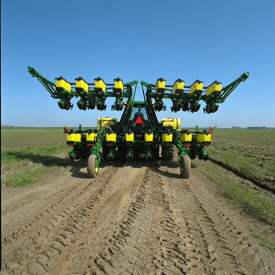 1725 16Row30 Stack-Fold Planter
1725 16Row30 Stack-Fold Planter
The 1725 Stack-Folding design provides narrow transport capability for these integral, large-frame planters without the need to empty hoppers. The 1725 Stack-Folding Planter has both rigid-frame and flex-frame configurations.
Three-section flex frames, available on 8-row wide and 12Row30 planters, flex 5 degrees up and 5 degrees down. The 16Row30 also utilizes a three-section frame that flexes 10 degrees up and 7 degrees down.
The 12-row wide planters with 91.4-cm, 96.5-cm, or 101.6-cm (36-in., 38-in., or 40-in.) spacings are equipped for rigid operation but can be modified in the field to provide frame flex. Productivity is improved with in-cab fold and go. Stack-folding frames utilize side-fold markers or can also be ordered without markers.
Lift-assist wheels may be required on 1725 Planters; check Tractor Compatibility Guide (1725 Stack-Folding Planter—Tractor Hitch Lift and Front Ballast Requirements).
The 1725 Stack-Fold Integral Planter is available in the following models:
-
8Row36, 8Row38, or 8Row40
- 12Row30, 12Row36, 12Row38, or 12Row40
- 16Row30
Transportability
| Model | Transport width with markers | Transport height* |
| 8Row - 91.4 cm (36 in.) | 5 m (16 ft, 5 in.) | 3.4 m (11 ft, 2 in.) |
| 8Row - 96.5 cm or 101.6 cm (38 in. or 40 in.) | 5.3 m (17 ft, 5 in.) | 3.4 m (11 ft, 2 in.) |
| 12Row - 76.2 cm (30 in.) | 6.2 m (20 ft, 3 in.) | 3.6 m (11 ft, 8 in.) |
| 12Row - 91.4 cm (36 in.) | 5.9 m (19 ft, 6 in.) | 4.04 m (13 ft, 3 in.) |
| 12Row - 96.5 cm or 101.6 cm (38 in. or 40 in.) | 7.2 m (23 ft, 8 in.) | 4.04 m (13 ft, 3 in.) |
| 16Row - 76.2 cm (30 in.) | 8.1 m (26 ft, 8 in.) | 4.01 m (13 ft, 2 in.) |
| *Height measured with 18.4R-46 rear tires on tractor | ||
Features
SeedStar™ 2 monitoring system
Integrated innovation is what operators will appreciate with the SeedStar 2 monitoring system and GreenStar™ 2 Display. An increasing number of acres combined with rising seed costs drive the need to easily understand planter functions and monitor performance. It is all about making every seed count and that is what SeedStar 2 delivers.
The SeedStar 2 monitoring system is a full-feature, color, seed population monitor used in conjunction with the GreenStar family of displays. SeedStar 2 is compatible with the GreenStar 2 1800 and 2600 Displays, GreenStar 3 2630 Display, the Gen 4 4200 CommandCenter™ Display, the Gen 4 4600 CommandCenter Display, the 4240 Universal Display, and the 4640 Universal Display. SeedStar 2 is not compatible with the Gen 4 Extended Monitor. Conveniently, SeedStar 2 planting functions are fully integrated with the full spectrum of Precision Ag Technology applications—guidance, coverage maps, and field documentation can be shown all on one display.
When a SeedStar 2 system is used on a planter, there is no need for a ComputerTrak™ monitor. All vital planting information is displayed in one central, easy-to-read location.
SeedStar 2 features
 SeedStar 2 full-screen planter run page
SeedStar 2 full-screen planter run page
SeedStar 2 is a user-friendly system that has retained all the valued features of SeedStar and incorporated the next generation of enhancements. For example, on-screen color indicators show drive engagement/disengagement status. In addition, three color planter-at-a-glance bars (black, orange, or red) visually inform the operator of row population status.
Not only does SeedStar 2 incorporate the use of color, it also utilizes an intuitive icon and folder based operator interface. Icons are easy to understand across many languages and reduce the need for text. Icons for planter main run page, planter setup, seed/crop setup, totals, and diagnostics are located in the soft-key region of the display. Setup is performed by selecting the appropriate icon and then choosing the tabs to enter/select information.
The SeedStar 2 monitor offers all of the features and functionality of the ComputerTrak 350 monitor and much more. SeedStar 2 monitors the following planter functions:
- Row population/spacing
- Row failure
- Average population (entire planter and by variable-rate drive [VRD] motor section)
- Vacuum level
- Fertilizer pressure
- Acre counter
- Total acreage
- Tractor speed
In addition, planter operational information is available within the SeedStar 2 monitor system. Such operational information includes population charts, seed disk vacuum settings, and setting recommendations for the piston pump liquid fertilizer system.
All SeedStar 2 systems have the capability, through a single controller, to perform both the seed monitoring and variable rate drive functions. SeedStar 2 monitoring is required for VRD population control. Even though the planter may not be equipped with SeedStar 2 VRD, the SeedStar 2 monitoring system is available and will allow for future installation of VRD.
SeedStar 2 enhancements
 SeedStar 2 half-screen planter run page
SeedStar 2 half-screen planter run page
 SeedStar 2 showing half-width disconnect status
SeedStar 2 showing half-width disconnect status
The SeedStar 2 enhanced planter features include:
- GreenStar 2 display integration – eliminates the need to operate the GreenStar 2 2600 Display in the original GreenStar monitor mode or the use of dual displays.
- User-friendly, intuitive icons
- Half- or full-screen run page
- On-screen, color drive status – a quick glance at the display tells the operator if the half-width disconnect is engaged or disengaged.
- Three-color planter-at-a-glance population bar – a black bar indicates that population is close to target and within established limits; orange shows the population is above/below the alarm set point; and red signals the population is out of operating range or is not planting.
- Three-piece, color VRD indicator – each piece of the VRD gear pie turns green when the wheel motion sensor is active, planter is lowered, and drives are engaged.
SeedStar monitoring original features
SeedStar 2 retains all those SeedStar features that producers value and have come to expect:
-
Planter at a glance – allows operator to view relative population levels of all rows on one screen.
-
Automatic valve calibration – with the SeedStar VRD, this is now completed automatically. There is no longer a need to manually calibrate the hydraulic valves.
-
Increased population updates – SeedStar will now update population levels once a second at planter start up then approximately once every three seconds.
-
Mapping of actual seed rates – When combined with Field Doc™ system, actual and target seeding rates can now be mapped in APEX™ software.
-
Reprogrammable utilizing controller area network (CAN) via Service ADVISOR™ diagnostics system.
-
Improved diagnostics/event recorder – on SeedStar VRD planters, additional diagnostic information is available, as well as an event recorder to capture system performance data at a specific point in time.
-
Ability to run motors at different population levels – on SeedStar VRD, operators running multiple motor systems can run each motor at a different speed, allowing different population levels within a planter.
-
User-configurable high fertilizer pressure alarm – allows the operator to be warned when fertilizer pressure reaches a specific level.
-
Automatic quick-start for SeedStar VRD – the operator no longer needs to press the quick-start button on end row turns to resume planting.
-
Automatic tractor speed source selection – when equipped with an 8000/9000 Series Tractor, the system selects the radar speed or allows for manual speed input selection.
Pneumatic downforce system
Pneumatic downforce provides convenient, simple adjustment of downforce for the whole planter from one location. The amount of downforce applied is infinitely adjustable from 0 kg to 181.4 kg (0 lb to 400 lb). Pneumatic downforce provides more consistent downforce throughout the range of row-unit travel than mechanical spring downforce systems.
Several pneumatic downforce system improvements have been implemented, including:
- 9.5-mm (3/8-in.) air delivery line instead of the 6.4-mm (1/4-in.) line used on model year 2010 and older planters.
- Air compressor assembly increased duty cycle. With this compressor, it provides a 47 percent increase in maximum air flow delivery compared to the prior air compressor.
- Pneumatic air bags with 9.5-mm (3/8-in.) air line inlets that have greater durability.
Such improvements to the pneumatic downforce system enable faster and more precise control of row-unit downforce while planting.
System features
 Pneumatic downforce spring
Pneumatic downforce spring

Each row-unit has a single, rubber air bag located between the parallel arms. The air bags are hooked in parallel so that air can be added or released from all rows at once from one location.
Pneumatic downforce systems are available as base equipment on all 1700 Series and DB Planters. The individual pneumatic downforce air bag assemblies, air compressor units, and 9.5-mm (3/8-in.) delivery lines are also available as an attachment for field conversion.
 Pneumatic downforce compressor and gauge
Pneumatic downforce compressor and gauge

An improved compressor is used to charge the pneumatic system. This compressor can be located on the planter frame or in the tractor cab if desired. A gauge at the compressor indicates the amount of downforce being applied.
From the factory, integral planter models with pneumatic downforce will have an improved air compressor assembly with an in-cab mounting bracket, except the 1725 16Row and 1725 Central Commodity System (CCS™) Twin-Row Planters which will have the air compressor assembly mounted on the planter frame. For drawn planter models, the 1755, 1765, 1765NT, 1775 Front-Fold, and 1785 Drawn Planters will have the air compressor assembly installed either on the outer hitch or wing frame members when the pneumatic downforce system is installed.
Row cleaner options to meet residue management needs
Crop yields have increased through the years along with the amount of residue left in the field after harvest. At the same time, tillage practices have changed, including different tillage operations which maintain large amounts of surface residue, and even no-till practices. Row cleaners are an essential tool in managing this increased amount of residue.
John Deere seeding group offers a variety of row cleaner options to meet the needs of a producer's operation. Compatibility varies by model, row spacing, and other planter equipment.
Screw-adjust, unit-mounted row cleaner
 Screw-adjust, unit-mounted row cleaner
Screw-adjust, unit-mounted row cleaner
The screw-adjust, unit-mounted row cleaner is mounted directly to the face plate of the row-unit, placing the ground engaging components just in front of the row-unit opener blades and depth gauge wheels. This close proximity allows the gauge wheels to control the depth of the row cleaner as well as the row-unit. This compact design also allows greater compatibility with fertilizer openers and other planter attachments.
SharkTooth® wheels are standard equipment on the unit-mounted row cleaner. The swept-tooth design of the wheel provides a clear path for the row-unit openers while resisting residue buildup on the wheel. The screw adjustment knob is accessible through the top of the parallel arms, providing convenient access for adjustments. The row cleaner can be adjusted in 1.6-mm (1/16-in.) increments, providing plenty of flexibility to meet the needs of changing conditions.
Floating row cleaner with unit-mounted coulter
 Floating row cleaner with unit-mounted coulter
Floating row cleaner with unit-mounted coulter
The floating row cleaner allows a row cleaner to be used in conjunction with a unit-mounted coulter. This combination is often desired in heavy residue loads and reduced tillage planting conditions. The row cleaner provides a clear path for the row-unit, while the unit-mounted coulter helps penetrate tough soil conditions.
Accommodating the unit-mounted coulter means the residue wheels are farther forward from the row-unit face plate than in the case of the screw-adjust row cleaner. To maintain performance, this row cleaner has the capability to float above a defined minimum depth.
Standard depth-gauging bands on the wheels allow the row cleaner wheels to float independently of the row-unit openers, allowing both to perform in varying terrain. The unit may also be set in a fixed position by simply pinning through the bracket if desired. This row cleaner also features SharkTooth wheels as standard equipment.
The floating row cleaner and unit-mounted coulters are available on many planters as factory-installed equipment. As compatibility and details vary by model, review the following links for information on specific planter models.
NOTE: Screw-adjust row cleaners are not compatible with MaxEmerge™ 5e row-units with long parallel arms.
NOTE: DB models have the option for either unit-mounted coulter, screw-adjust row cleaners, or pneumatic row cleaners (only compatabile with MaxEmerge 5e or equipped ExactEmerge™ models). The DB60T is only available with a less row cleaner option.
SharkTooth is a trademark of Yetter Manufacturing, Inc.
Seed variable-rate drive
Seed variable-rate drive provides the ultimate planting productivity by utilizing one, two, or three hydraulic motors (varies by model) to turn the seeding drive shaft. Hydraulic control of the seeding drive allows for on-the-go seeding rate changes right from the display mounted inside the tractor cab. Combine this seeding flexibility with the map-based planting option, and seeding rates adjust automatically based on the prescribed map.
Variable-rate drive offers the following advantages over common, ground, or contact-tire drive systems:
-
Rate changes are almost instantaneous; no ramp up or ramp down of system as in some competitive systems
- Permits the producer to match seed population based on different soil types or irrigation practices
- John Deere design provides added operator safety by eliminating any possible drive creep found in some competitive variable-rate drive systems
 1755 equipped with variable-rate drive
1755 equipped with variable-rate drive
 1765NT equipped with variable-rate drive
1765NT equipped with variable-rate drive
Single- or dual-motor systems for variable-rate drives are available for all John Deere planters except the 1785 Rigid Frame. Variable-rate drive is available as a factory-installed option for all applicable planter models.
Single- or dual-motor systems are available as field-installed attachments for most planter models; however, a three-motor variable-rate drive field-installed attachment is not available.
Seed variable-rate drive requires the SeedStar™ monitor and a radar input signal. Either tractor or planter radar may be used. Planter radar is ordered separately.
NOTE: Peanut seed meter disks require the variable-drive transmission.
MaxEmerge™ 5 row-unit
 MaxEmerge 5 with 56-L (1.6-bu) hopper plus insecticide
MaxEmerge 5 with 56-L (1.6-bu) hopper plus insecticide
 MaxEmerge 5 with mini-hopper on Central Commodity System (CCS™) machines only
MaxEmerge 5 with mini-hopper on Central Commodity System (CCS™) machines only
The MaxEmerge family of row-units have never seen a more versatile and efficient design until the MaxEmerge 5. The 5-family row-units improve productivity, increase uptime and lower the cost of ownership like never before.
The MaxEmerge 5 row-unit was designed for improved performance and serviceability.


Serviceability and changing crops has always been a focus of downtime and potential seed loss. MaxEmerge XP row-units (shown on the left) are designed with the meter and hopper as one component. The frame covers the meter so that it cannot be accessed. Cleanout of excess seed requires the operator to take the entire hopper off of the row-unit and to turn it upside down. The MaxEmerge 5 meter (shown on the right) is accessible without having to remove the box. The MaxEmerge 5 design allows large hoppers to be cleaned out the same as mini-hoppers, simply by opening the meter dome and catching the seed as it falls out. This improvement allows operators to change seed varieties easier and three times faster than it took them on the previous MaxEmerge XP units and provides more uptime during the tight planting window.
 MaxEmerge 5 vacuum seed meter
MaxEmerge 5 vacuum seed meter
The vacuum meter system gently pulls and holds individual seeds to the holes of the seed disk for population control and spacing accuracy, equaling better crop stands and profit. Vacuum seed meters can plant a wide variety of crops and seed types by simply changing seed disks and adjusting vacuum level. Vacuum seed meters are available for planters with MaxEmerge 5 row-units.
Additional features of the vacuum seed meter include:
- One moving component (the seed metering disk) for minimum maintenance requirements
- Meter located at each row-unit for accurate seed delivery
- Good hopper seed flow characteristics for longer operating time per hopper fill
- Low airflow in meter so seed treatments are not removed
 Pro-Series™ row-unit seed pool
Pro-Series™ row-unit seed pool
 MaxEmerge 5 seed pool
MaxEmerge 5 seed pool
The MaxEmerge 5 meter shape has also been redesigned for better seed flow. The mini-hopper design allows the planter to successfully operate on side hills up to 14 degrees.
Vacuum meter hub and latching handle
 MaxEmerge 5 vacuum meter with disk
MaxEmerge 5 vacuum meter with disk
Both the MaxEmerge 5 vacuum meters are equipped with a heavy-duty hub spring and disk latching handle. The spring ensures the seed disk stays properly positioned when operating flat-style seed disks and higher vacuum levels. Proper seed disk positioning means repeatable seed singulation, time after time. The disk-latching handle is designed for easy operation and effortless seed disk changeover. The hub is also machined to tight tolerances to further ensure alignment of metering components.
 Flat-style and cell seed disks shown
Flat-style and cell seed disks shown
The unique cell disk design allows planting a variety of seed sizes without any additional parts or individual meter adjustments. Another advantage of cell-type seed disks is the lower vacuum requirement compared to flat-style seed disks. Lower vacuum levels mean less hydraulic demand from the tractor. Most planting conditions call for a flat disk, if you are limited in hydraulic capacity, cell disks are recommended.
Operating characteristics of vacuum seed meter
 Operating speed with seed tube technology
Operating speed with seed tube technology
The vacuum seed meter is capable of operating at faster planting speeds than mechanical meters. However, planting accuracy will be influenced by seedbed conditions and the operating characteristics of the seed meter. Rough seedbeds and fast planting speeds (above 8.9 km/h [5.5 mph]) typically deteriorate seed placement accuracies when using seed tube technology.
The chart illustrates the effect operating speed has on population when using the vacuum meter. The operating band (color area) illustrates how the vacuum meter performs in relation to the desired population (indicated by horizontal line). The width of the band is due to various sizes and shapes of seeds and planting rate variations.
When operating on slopes above 15 degrees, increased or decreased population may result. To minimize this effect, reduce speed and consider using a flat style seed disk with increased vacuum level.
Vacuum meter seed disks
The ProMax 40 Flat Disk is a flat-disk planting solution field-proven to work since 1991.

The design of the ProMax 40 Flat Disk position allows seed to be released from the optimum position above the seed tube. The flush-face seed tube allows the seed to drop uninterrupted through the tube.
The ProMax 40 Flat Disk utilizes flat holes and a higher vacuum level to ensure every hole is populated with a seed. A double eliminator gently removes multiple seeds at each hole for precise population control. A knockout wheel makes certain that each hole is clear of any debris after the seed is released from the disk.
Double eliminator

For difficult to singulate seeds, a flat seed disk and double eliminator is a viable alternative to traditional cell-type seed disks. By design, a flat seed disk requires higher levels of vacuum than a cell-type disk because there is no pocket or cell to hold the seed. The higher vacuum level will pull more than one seed to the holes in the seed disk. The double eliminator is set to cover a portion of the hole in the seed disk and is the mechanism to knock multiple seeds away as the disk rotates.
Double eliminators are required with flat-type seed disks only and should not be used with cell-type seed disks. The knockout wheel is also recommended in conjunction with the double eliminator and flat seed disk to ensure seed is ejected from the disk.
Flat and celled type seed metering disks are available to allow planting a wide variety of seed types.
- Corn (field, popcorn, or sweet corn)
- Soybeans
- Cotton
- Sorghum
- Sugar beets
- Sunflowers
- Edible beans/peas
- Peanuts
- Melons, squash, cucumbers
Mini-hopper row-units, which are used only with the CCS, are compatible only with crops that the CCS is approved to plant.
- Corn
- Popcorn
- Sweet corn
- Soybeans
- Sunflowers
- Sorghum
- Cotton
NOTE: Due to small seed size and low planting populations, sugar beets can be planted with mini-hopper style meters by adding hopper extensions and not using the CCS tank. These hopper extensions can also be used for planting test plots.
 Hopper shutoff
Hopper shutoff

Also, to help with meter access of 56-L and 106-L (1.6-bu and 3-bu) hoppers the hopper shutoff feature was added. With the shutoff engaged, the meter cover can be opened without first having to remove all of the seeds from the hopper. Lever down, the seed flow is on, lever horizontal and the seed flow is off.
 MaxEmerge 5 mini-hopper
MaxEmerge 5 mini-hopper

There are significant changes to the MaxEmerge 5 mini-hopper. One update is the straight feed from the CCS hose to the mini-hopper to ensure a continuous free flow of seeds. This design change reduces the potential for plugging issues with larger seed size and the use of seed treatments. By drawing air from the CCS tank, the vacuum source is cleaner, preventing meter debris buildup.
 Ductile iron-cast shank
Ductile iron-cast shank

Ductile iron casting is a unique high-tech process that produces a single-piece row-unit shank this enables alignment from the seed trench to the closing wheel.
The row-unit head is also designed using the ductile iron-casting process. The row-unit head provides the mating joints between the row-unit parallel arms and the row-unit shank. It is also the upper attaching point for the seed meter and seed hopper.
Ductile iron casting of the row-unit shank and head assembly provides a row-unit that is 25 percent stronger than other competitive welded row-units.
 Rubber tire closing system
Rubber tire closing system
 Cast wheel closing system
Cast wheel closing system
Rubber tire closing systems are used for most conventional, minimum-till, and no-till planting conditions. The spacing between the wheels is adjustable so the closing system can meet the needs of those who want to plant small seeds at shallow depths.
The wheels can also be staggered fore and aft to enhance residue flow. Four levels of spring force are available and are easily set with the integrated T-handle adjustment. A lower force spring can be obtained from parts, if a lower amount of force is required.
Additional closing wheel options include:
- Cast closing wheels, for tough-to-close conditions
- Disk closing, for shallow planting depths
- Closing wheel frame less wheels, for growers desiring to use aftermarket closing wheels

One of the trademark capabilities of John Deere planters has always been the ability of the Tru-Vee openers to provide an ideal seed furrow.
The thickness of the Tru-Vee opener blade is 3.5 mm (0.14 in.) this blade thickness will provide extended wear life.
The MaxEmerge 5 row-unit also provides better Tru-Vee opener bearings for longer life. The double-row ball bearing provides up to three times the wear life as the single-row bearing.
 Depth adjustment T-handle
Depth adjustment T-handle

John Deere planters provide consistent seed depth control in all field conditions. Depth control is a function of the Tru-Vee openers, the downforce system, and the gauge wheel assembly.
The gauge wheel itself is made of durable nylon composition with a concave profile. This profile gently firms the sides of the seed furrow, ensuring a well-defined trench. The shape reduces rocks and residue being picked up and thrown onto the drive chains and row-units, and helps to prevent rooster tailing of soil.
The bolt-through design utilizes an open bearing in the gauge wheel that allows an attaching bolt to pass through the wheel to the threaded hole in the gauge wheel arm. This simple bolt-through design provides for a positive attachment of the gauge wheel to the gauge wheel arm and allows quick removal of the gauge wheel for service.
Adjustability of the row-unit is critical to good performance. More available downforce options than any row unit in the industry
- Adjustable heavy-duty downforce, four settings, 0 kg (0 lb), 57 kg (125 lb), 113 kg (250 lb), and 181 kg (400 lb) of downforce
- Pneumatic downforce, infinitely variable from 0 to 181 kg (0 to 400 lb) of downforce
- Active pneumatic downforce adjusts automatically for changing ground conditions from 0 to 181 kg (0 to 400 lb) of downforce
1715 Planter - integral vertical-folding
1715 frame provides economical narrow transport
 1715 12-Row Vertical-Fold Planter
1715 12-Row Vertical-Fold Planter
The 1715 Integral Planter wings fold vertically for narrow transport. Wing row-unit hoppers must be emptied for transport.
Vertical-fold planters have four wheels mounted to the rear of the frame. The 1715 Planter is base-equipped with two centerframe drive wheels. Optional drive by two center and two wing wheels is available and required when wings are pinned for rigid operation.
Liquid fertilizer is available for the 12Row30 frame.
The 1715 Vertical-Fold Integral Planter is available in the following models:
- 12Row30
- 12Row70
Transportability
 1715 12-Row Vertical-Fold Planter in transport
1715 12-Row Vertical-Fold Planter in transport
Wings fold hydraulically and are manually locked up for transport. Frame will flex 8 degrees up and 6 degrees down to follow rolling ground and conform to terraces. Wings can be pinned rigid when planting on beds or flatland.
Vacuum system
 Vacuum system
Vacuum system
Vacuum blower assembly
 Vacuum blower shown on 1795
Vacuum blower shown on 1795

Vacuum is created by a hydraulically driven vacuum blower assembly mounted on the planter frame. The vacuum blower requires a tractor with a closed-center hydraulic system and a separate selective control valve (SCV). For tractors with open-center hydraulic system, a vacuum 540-rpm or 1000-rpm power take-off (PTO) driven hydraulic pump system is available. PTO pumps offered from the factory are limited to 15-row applications or less.
Different vacuum levels are required depending on the crop being planted. A hydraulic control valve lets the operator regulate vacuum blower speed, changing the vacuum level. On late-model John Deere tractors, vacuum levels are set from the tractor seat using the SCV controls. The control valve is not needed in those applications. At full flow, the system flows up to 18.9 L/min (5 gpm) per motor.
Convenient vacuum gauges located on the planter hitch give a visual indication of the vacuum level. When using a SeedStar™ monitor, the vacuum level can be displayed on the monitor. Consult the vacuum metering seed charts in the operator's manual for initial vacuum setting recommendations.
Vacuum meter case drain
 Case drain coupler 7000 Series Tractor
Case drain coupler 7000 Series Tractor

All planters with vacuum metering systems have case drain motors on the vacuum blowers. Case drain lines will have a flush-face case drain coupler on the planter and will require a corresponding flush-face case drain coupler on the tractor. The flush-face coupler simplifies implement attachment by allowing operators to easily identify the case drain. The unique hose tip is unable to connect to another coupler on the tractor, ensuring the correct setup.
It is important to connect this case drain hose to prevent the continuous and complete draining of hydraulic fluid due to the relief feature that opens the coupler when the pressure reaches 68.9 kPa (10 psi). This relief feature is designed to protect the motor shaft seal if for any reason the case drain hose was not connected to the tractor. The flush-face hose tips have less back pressure than ISO case drain tips, and the flat surface makes these couplers easy to clean, providing less chance for contamination.
The case drain line is also used with all Central Commodity System (CCS™) fan motors.
Features
SeedStar™ 2 monitoring system
Integrated innovation is what operators will appreciate with the SeedStar 2 monitoring system and GreenStar™ 2 Display. An increasing number of acres combined with rising seed costs drive the need to easily understand planter functions and monitor performance. It is all about making every seed count and that is what SeedStar 2 delivers.
The SeedStar 2 monitoring system is a full-feature, color, seed population monitor used in conjunction with the GreenStar family of displays. SeedStar 2 is compatible with the GreenStar 2 1800 and 2600 Displays, GreenStar 3 2630 Display, the Gen 4 4200 CommandCenter™ Display, the Gen 4 4600 CommandCenter Display, the 4240 Universal Display, and the 4640 Universal Display. SeedStar 2 is not compatible with the Gen 4 Extended Monitor. Conveniently, SeedStar 2 planting functions are fully integrated with the full spectrum of Precision Ag Technology applications—guidance, coverage maps, and field documentation can be shown all on one display.
When a SeedStar 2 system is used on a planter, there is no need for a ComputerTrak™ monitor. All vital planting information is displayed in one central, easy-to-read location.
SeedStar 2 features
 SeedStar 2 full-screen planter run page
SeedStar 2 full-screen planter run page
SeedStar 2 is a user-friendly system that has retained all the valued features of SeedStar and incorporated the next generation of enhancements. For example, on-screen color indicators show drive engagement/disengagement status. In addition, three color planter-at-a-glance bars (black, orange, or red) visually inform the operator of row population status.
Not only does SeedStar 2 incorporate the use of color, it also utilizes an intuitive icon and folder based operator interface. Icons are easy to understand across many languages and reduce the need for text. Icons for planter main run page, planter setup, seed/crop setup, totals, and diagnostics are located in the soft-key region of the display. Setup is performed by selecting the appropriate icon and then choosing the tabs to enter/select information.
The SeedStar 2 monitor offers all of the features and functionality of the ComputerTrak 350 monitor and much more. SeedStar 2 monitors the following planter functions:
- Row population/spacing
- Row failure
- Average population (entire planter and by variable-rate drive [VRD] motor section)
- Vacuum level
- Fertilizer pressure
- Acre counter
- Total acreage
- Tractor speed
In addition, planter operational information is available within the SeedStar 2 monitor system. Such operational information includes population charts, seed disk vacuum settings, and setting recommendations for the piston pump liquid fertilizer system.
All SeedStar 2 systems have the capability, through a single controller, to perform both the seed monitoring and variable rate drive functions. SeedStar 2 monitoring is required for VRD population control. Even though the planter may not be equipped with SeedStar 2 VRD, the SeedStar 2 monitoring system is available and will allow for future installation of VRD.
SeedStar 2 enhancements
 SeedStar 2 half-screen planter run page
SeedStar 2 half-screen planter run page
 SeedStar 2 showing half-width disconnect status
SeedStar 2 showing half-width disconnect status
The SeedStar 2 enhanced planter features include:
- GreenStar 2 display integration – eliminates the need to operate the GreenStar 2 2600 Display in the original GreenStar monitor mode or the use of dual displays.
- User-friendly, intuitive icons
- Half- or full-screen run page
- On-screen, color drive status – a quick glance at the display tells the operator if the half-width disconnect is engaged or disengaged.
- Three-color planter-at-a-glance population bar – a black bar indicates that population is close to target and within established limits; orange shows the population is above/below the alarm set point; and red signals the population is out of operating range or is not planting.
- Three-piece, color VRD indicator – each piece of the VRD gear pie turns green when the wheel motion sensor is active, planter is lowered, and drives are engaged.
SeedStar monitoring original features
SeedStar 2 retains all those SeedStar features that producers value and have come to expect:
-
Planter at a glance – allows operator to view relative population levels of all rows on one screen.
-
Automatic valve calibration – with the SeedStar VRD, this is now completed automatically. There is no longer a need to manually calibrate the hydraulic valves.
-
Increased population updates – SeedStar will now update population levels once a second at planter start up then approximately once every three seconds.
-
Mapping of actual seed rates – When combined with Field Doc™ system, actual and target seeding rates can now be mapped in APEX™ software.
-
Reprogrammable utilizing controller area network (CAN) via Service ADVISOR™ diagnostics system.
-
Improved diagnostics/event recorder – on SeedStar VRD planters, additional diagnostic information is available, as well as an event recorder to capture system performance data at a specific point in time.
-
Ability to run motors at different population levels – on SeedStar VRD, operators running multiple motor systems can run each motor at a different speed, allowing different population levels within a planter.
-
User-configurable high fertilizer pressure alarm – allows the operator to be warned when fertilizer pressure reaches a specific level.
-
Automatic quick-start for SeedStar VRD – the operator no longer needs to press the quick-start button on end row turns to resume planting.
-
Automatic tractor speed source selection – when equipped with an 8000/9000 Series Tractor, the system selects the radar speed or allows for manual speed input selection.
Pneumatic downforce system
Pneumatic downforce provides convenient, simple adjustment of downforce for the whole planter from one location. The amount of downforce applied is infinitely adjustable from 0 kg to 181.4 kg (0 lb to 400 lb). Pneumatic downforce provides more consistent downforce throughout the range of row-unit travel than mechanical spring downforce systems.
Several pneumatic downforce system improvements have been implemented, including:
- 9.5-mm (3/8-in.) air delivery line instead of the 6.4-mm (1/4-in.) line used on model year 2010 and older planters.
- Air compressor assembly increased duty cycle. With this compressor, it provides a 47 percent increase in maximum air flow delivery compared to the prior air compressor.
- Pneumatic air bags with 9.5-mm (3/8-in.) air line inlets that have greater durability.
Such improvements to the pneumatic downforce system enable faster and more precise control of row-unit downforce while planting.
System features
 Pneumatic downforce spring
Pneumatic downforce spring

Each row-unit has a single, rubber air bag located between the parallel arms. The air bags are hooked in parallel so that air can be added or released from all rows at once from one location.
Pneumatic downforce systems are available as base equipment on all 1700 Series and DB Planters. The individual pneumatic downforce air bag assemblies, air compressor units, and 9.5-mm (3/8-in.) delivery lines are also available as an attachment for field conversion.
 Pneumatic downforce compressor and gauge
Pneumatic downforce compressor and gauge

An improved compressor is used to charge the pneumatic system. This compressor can be located on the planter frame or in the tractor cab if desired. A gauge at the compressor indicates the amount of downforce being applied.
From the factory, integral planter models with pneumatic downforce will have an improved air compressor assembly with an in-cab mounting bracket, except the 1725 16Row and 1725 Central Commodity System (CCS™) Twin-Row Planters which will have the air compressor assembly mounted on the planter frame. For drawn planter models, the 1755, 1765, 1765NT, 1775 Front-Fold, and 1785 Drawn Planters will have the air compressor assembly installed either on the outer hitch or wing frame members when the pneumatic downforce system is installed.
1705T downforce options
Pneumatic downforce springs
 Pneumatic downforce system
Pneumatic downforce system

Pneumatic downforce provides convenient, simple adjustment of downforce for the whole planter from one location. The amount of downforce applied is infinitely adjustable from 0 kg to 181.4 kg (0 lb to 400 lb). Pneumatic downforce provides more consistent downforce throughout the range of row-unit travel than mechanical-spring downforce systems. Each row-unit has a single rubber air bag located between the parallel arms. The air bags are hooked in parallel so that air can be added or released from all rows at once from one location.
Pneumatic downforce systems are available as base equipment on all 1705 Series and DB Planters.
Pneumatic downforce with spring upforce kit
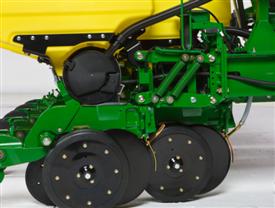 Pneumatic downforce with spring upforce kit
Pneumatic downforce with spring upforce kit
 Spring upforce kit
Spring upforce kit
Pneumatic downforce with spring upforce kit option includes the same convenient, simple adjustment of downforce with up to 81.6 kg (180 lb) of upforce per row-unit. Dual upforce springs provide the row-unit upforce to increase flotation in softer soils. This upforce can also be used to counteract excess row-unit margin or extra weight cause by seed, tillage, or other attachments on the row-unit. Upforce springs will limit the maximum amount of downforce that can be placed on a row-unit by the downforce system and should only be used in conditions were adequate and consistent depth control is easily maintained.
Seed variable-rate drive
Seed variable-rate drive provides the ultimate planting productivity by utilizing one, two, or three hydraulic motors (varies by model) to turn the seeding drive shaft. Hydraulic control of the seeding drive allows for on-the-go seeding rate changes right from the display mounted inside the tractor cab. Combine this seeding flexibility with the map-based planting option, and seeding rates adjust automatically based on the prescribed map.
Variable-rate drive offers the following advantages over common, ground, or contact-tire drive systems:
-
Rate changes are almost instantaneous; no ramp up or ramp down of system as in some competitive systems
- Permits the producer to match seed population based on different soil types or irrigation practices
- John Deere design provides added operator safety by eliminating any possible drive creep found in some competitive variable-rate drive systems
 1755 equipped with variable-rate drive
1755 equipped with variable-rate drive
 1765NT equipped with variable-rate drive
1765NT equipped with variable-rate drive
Single- or dual-motor systems for variable-rate drives are available for all John Deere planters except the 1785 Rigid Frame. Variable-rate drive is available as a factory-installed option for all applicable planter models.
Single- or dual-motor systems are available as field-installed attachments for most planter models; however, a three-motor variable-rate drive field-installed attachment is not available.
Seed variable-rate drive requires the SeedStar™ monitor and a radar input signal. Either tractor or planter radar may be used. Planter radar is ordered separately.
NOTE: Peanut seed meter disks require the variable-drive transmission.
Vacuum system
 Vacuum system
Vacuum system
Vacuum blower assembly
 Vacuum blower shown on 1795
Vacuum blower shown on 1795

Vacuum is created by a hydraulically driven vacuum blower assembly mounted on the planter frame. The vacuum blower requires a tractor with a closed-center hydraulic system and a separate selective control valve (SCV). For tractors with open-center hydraulic system, a vacuum 540-rpm or 1000-rpm power take-off (PTO) driven hydraulic pump system is available. PTO pumps offered from the factory are limited to 15-row applications or less.
Different vacuum levels are required depending on the crop being planted. A hydraulic control valve lets the operator regulate vacuum blower speed, changing the vacuum level. On late-model John Deere tractors, vacuum levels are set from the tractor seat using the SCV controls. The control valve is not needed in those applications. At full flow, the system flows up to 18.9 L/min (5 gpm) per motor.
Convenient vacuum gauges located on the planter hitch give a visual indication of the vacuum level. When using a SeedStar™ monitor, the vacuum level can be displayed on the monitor. Consult the vacuum metering seed charts in the operator's manual for initial vacuum setting recommendations.
Vacuum meter case drain
 Case drain coupler 7000 Series Tractor
Case drain coupler 7000 Series Tractor

All planters with vacuum metering systems have case drain motors on the vacuum blowers. Case drain lines will have a flush-face case drain coupler on the planter and will require a corresponding flush-face case drain coupler on the tractor. The flush-face coupler simplifies implement attachment by allowing operators to easily identify the case drain. The unique hose tip is unable to connect to another coupler on the tractor, ensuring the correct setup.
It is important to connect this case drain hose to prevent the continuous and complete draining of hydraulic fluid due to the relief feature that opens the coupler when the pressure reaches 68.9 kPa (10 psi). This relief feature is designed to protect the motor shaft seal if for any reason the case drain hose was not connected to the tractor. The flush-face hose tips have less back pressure than ISO case drain tips, and the flat surface makes these couplers easy to clean, providing less chance for contamination.
The case drain line is also used with all Central Commodity System (CCS™) fan motors.
Features
Folding markers
 Folding marker
Folding marker
A 406-mm (16-in.) notched marker disk blade with a 102-mm (4-in.) wide depth gauging band is base equipment on folding markers. Notched marker disk blades are compatible with all tillage conditions but are recommended for no-till and high-residue mulch-till conditions. This marker uses a 44.45-mm (1.75-in.) square tube marker arm extension.
Folding markers are base equipment on the following planter model configurations:
- 1755 8Row30
- 1785 8Row30, 15Row15
Although not in base equipment, folding markers are available for the following integral planter configurations:
-
1705 6Row30, 6Row36, 6Row38, 6Row40, 8Row30, 8Row38, 8Row40, and all 10Row
-
1715 all rows
-
1735 all 12,13, and 15Row
Vacuum system

Vacuum blower assembly
 Vacuum blower shown on 1795
Vacuum blower shown on 1795

Vacuum is created by a hydraulically driven vacuum blower assembly mounted on the planter frame. The vacuum blower requires a tractor with a closed-center hydraulic system and a separate selective control valve (SCV). For tractors with open-center hydraulic system, a vacuum 540- or 1000-rpm power take-off (PTO)-driven hydraulic pump system is available. PTO pumps offered from the factory are limited to 15-row applications or less.
Different vacuum levels are required depending on the crop being planted. A hydraulic control valve lets the operator regulate vacuum blower speed, changing the vacuum level. On late-model John Deere tractors, vacuum levels are set from the tractor seat using the SCV controls. The control valve is not needed in those applications. At full flow, the system flows up to 18.9 L/min (5 gpm) per motor.
Convenient vacuum gauges located on the planter hitch give a visual indication of the vacuum level. When using a SeedStar™ monitor, the vacuum level can be displayed on the monitor. Consult the vacuum metering seed charts in the operator's manual for initial vacuum setting recommendations.
Vacuum meter case drain
 Case drain coupler 7000 Series Tractor
Case drain coupler 7000 Series Tractor

All planters with vacuum metering systems have case drain motors on the vacuum blowers. Case drain lines will have a flush-face case drain coupler on the planter and will require a corresponding flush-face case drain coupler on the tractor. The flush-face coupler simplifies implement attachment by allowing operators to easily identify the case drain. The unique hose tip is unable to connect to another coupler on the tractor, ensuring the correct setup.
It is important to connect this case drain hose to prevent the continuous and complete draining of hydraulic fluid due to the relief feature that opens the coupler when the pressure reaches 10 psi. This relief feature is designed to protect the motor shaft seal if for any reason the case drain hose was not connected to the tractor. The flush-face hose tips have less back pressure than ISO case drain tips, and the flat surface makes these couplers easy to clean, providing less chance for contamination.
The case drain line is also used with all Central Commodity System (CCS™) fan motors.
SeedStar™ 2 monitoring system
Integrated innovation--that is what operators will appreciate with the SeedStar 2 monitoring system and GreenStar™ 2 (GS2) Display. An increasing number of acres combined with rising seed costs drive the need to easily understand planter functions and monitor performance. It is all about making every seed count and that is what SeedStar 2 delivers.
The SeedStar 2 monitoring system is a full-feature, color, seed population monitor used in conjunction with the GreenStar family of displays (Generation 4 CommandCenter™ controls with premium activation, GS 2630, GS 2600 Display or the entry-level GS2 1800 Display). Conveniently, SeedStar 2 planting functions are fully integrated with the full spectrum of AMS applications—guidance, coverage maps, and field documentation can be shown all on one display.
When a SeedStar 2 system is used on a planter, there is no need for a ComputerTrak™ monitor. All vital planting information is displayed in one central, easy-to-read location.
SeedStar 2 features
 SeedStar 2 full-screen planter run page
SeedStar 2 full-screen planter run page
SeedStar 2 is a user-friendly system that has retained all the valued features of SeedStar and incorporated the next generation of enhancements. For example, on-screen, color indicators shows drive engagement/disengagement status. In addition, three color (black, orange, or red) planter at a glance bars visually inform the operator of row population status.
Not only does SeedStar 2 incorporate the use of color, it also utilizes an intuitive icon and folder based operator interface. Icons are easy to understand across many languages and reduce the need for text. Icons for planter main run page, planter setup, seed/crop setup, totals, and diagnostics are located in the soft-key region of the display. Setup is performed by selecting the appropriate icon and then choosing the tabs to enter/select information.
The SeedStar 2 monitor offers all of the features and functionality of the ComputerTrak™ 350 monitor and much more. SeedStar 2 monitors the following planter functions:
- Row population/spacing
- Row failure
- Average population (entire planter and by variable-rate drive [VRD] motor section)
- Vacuum level
- Fertilizer pressure
- Acre counter
- Total acreage
- Tractor speed
In addition, planter operational information is available within the SeedStar 2 monitor system. Such operational information includes population charts, seed disk vacuum settings, and setting recommendations for the piston pump liquid fertilizer system.
All SeedStar 2 systems have the capability, through a single controller, to perform both the seed monitoring and variable rate drive functions. SeedStar 2 monitoring is required for VRD population control. Even though the planter may not be equipped with SeedStar 2 VRD, the SeedStar 2 monitoring system is available and will allow for future installation of VRD.
SeedStar 2 enhancements
 SeedStar 2 half-screen planter run page
SeedStar 2 half-screen planter run page
 SeedStar 2 showing half-width disconnect status
SeedStar 2 showing half-width disconnect status
The SeedStar 2 enhanced planter features include:
- GreenStar 2 display integration. Eliminates the need to operate the GS2 2600 Display in the original GreenStar monitor mode or the use of dual displays.
- User-friendly, intuitive icons
- Half- or full-screen run page
- On-screen, color drive status; a quick glance at the display tells the operator if the half-width disconnect is engaged or disengaged.
- Three-color planter-at-a-glance population bar. A black bar indicates that population is close to target and within established limits; orange shows the population is above/below the alarm set point; red signals the population is out of operating range or is not planting.
- Three-piece, color VRD indicator. Each piece of the VRD gear pie turns green when the wheel motion sensor is active, planter is lowered, and drives are engaged.
SeedStar monitoring original features
SeedStar 2 retains all those SeedStar features that producers value and have come to expect:
-
Planter at a glance. Allows operator to view relative population levels of all rows on one screen.
-
Automatic valve calibration. With the SeedStar VRD, this is now completed automatically. There is no longer a need to manually calibrate the hydraulic valves.
-
Increased population updates. SeedStar will now update population levels once a second at planter start up then approximately once every three seconds.
-
Mapping of actual seed rates. When combined with Field Doc™ system, actual and target seeding rates can now be mapped in Apex™ software.
-
Reprogrammable utilizing CAN via Service ADVISOR™ diagnostics system.
-
Improved diagnostics/event recorder. On SeedStar VRD planters, additional diagnostic information is available, as well as an event recorder to capture system performance data at a specific point in time.
-
Ability to run motors at different population levels. On SeedStar VRD, operators running multiple motor systems can run each motor at a different speed, allowing different population levels within a planter.
-
User-configurable high fertilizer pressure alarm. Allows the operator to be warned when fertilizer pressure reaches a specific level.
-
Automatic quick-start for SeedStar VRD. No longer does the operator need to press the quick-start button on end row turns to resume planting.
-
Automatic tractor speed source selection. When equipped with an 8000/9000 Series Tractor, the system selects the radar speed or allows for manual speed input selection.
MaxEmerge™ 5 row-unit
 MaxEmerge 5 with 56-L (1.6-bu) hopper plus insecticide
MaxEmerge 5 with 56-L (1.6-bu) hopper plus insecticide
 MaxEmerge 5 with mini hopper on CCS™ machines only
MaxEmerge 5 with mini hopper on CCS™ machines only
The MaxEmerge family of row-units have never seen a more versatile and efficient design until the MaxEmerge 5. The 5-family row-units improve productivity, increase uptime and lower the cost of ownership like never before.
The MaxEmerge 5 row-unit was designed for improved performance and serviceability.


Serviceability and changing crops has always been a focus of downtime and potential seed loss. MaxEmerge XP row-units (shown on the left) are designed with the meter and hopper as one component. The frame covers the meter so that it cannot be accessed. Cleanout of excess seed requires the operator to take the entire hopper off of the row-unit and to turn it upside down. The MaxEmerge 5 meter (shown on the right) is accessible without having to remove the box. The MaxEmerge 5 design allows large hoppers to be cleaned out the same as mini-hoppers, simply by opening the meter dome and catching the seed as it falls out. This improvement allows operators to change seed varieties easier and three times faster than it took them on the previous MaxEmerge XP units and provides more uptime during the tight planting window.
 MaxEmerge™ 5 vacuum seed meter
MaxEmerge™ 5 vacuum seed meter
The vacuum meter system gently pulls and holds individual seeds to the holes of the seed disk for population control and spacing accuracy, equaling better crop stands and profit. Vacuum seed meters can plant a wide variety of crops and seed types by simply changing seed disks and adjusting vacuum level. Vacuum seed meters are available for planters with MaxEmerge 5 row-units.
Additional features of the vacuum seed meter include:
- One moving component (the seed metering disk) for minimum maintenance requirements
- Meter located at each row-unit for accurate seed delivery
- Good hopper seed flow characteristics for longer operating time per hopper fill
- Low airflow in meter so seed treatments are not removed
 Pro-Series™ seed pool
Pro-Series™ seed pool
 MaxEmerge 5 seed pool
MaxEmerge 5 seed pool
The MaxEmerge 5 meter shape has also been redesigned for better seed flow. The mini-hopper design allows the planter to successfully operate on side hills up to 14 degrees.
Vacuum meter hub and latching handle
 MaxEmerge 5 vacuum meter with disk
MaxEmerge 5 vacuum meter with disk
Both the MaxEmerge 5 vacuum meters are equipped with a heavy-duty hub spring and disk latching handle. The spring ensures the seed disk stays properly positioned when operating flat-style seed disks and higher vacuum levels. Proper seed disk positioning means repeatable seed singulation, time after time. The disk-latching handle is designed for easy operation and effortless seed disk changeover. The hub is also machined to tight tolerances to further ensure alignment of metering components.
Operating characteristics of vacuum seed meter
 Operating speed with seed tube technology
Operating speed with seed tube technology
The vacuum seed meter is capable of operating at faster planting speeds than mechanical meters. However, planting accuracy will be influenced by seedbed conditions and the operating characteristics of the seed meter. Rough seedbeds and fast planting speeds (above 8.9 km/h [5.5 mph]) typically deteriorate seed placement accuracies when using seed tube technology.
The chart illustrates the effect operating speed has on population when using the vacuum meter. The operating band (color area) illustrates how the vacuum meter performs in relation to the desired population (indicated by horizontal line). The width of the band is due to various sizes and shapes of seeds and planting rate variations.
When operating on slopes above 15 degrees, increased or decreased population may result. To minimize this effect, reduce speed and consider using a flat style seed disk with increased vacuum level.
Vacuum meter seed disks
The ProMAX 40 Flat Disk: The flat-disk planting solution field-proven to work since 1991

The design of the ProMAX 40 Flat Disk position allows seed to be released from the optimum position above the seed tube. The flush-face seed tube allows the seed to drop uninterrupted through the tube.
The ProMAX 40 Flat Disk utilizes flat holes and a higher vacuum level to ensure every hole is populated with a seed. A double eliminator gently removes multiple seeds at each hole for precise population control. A knockout wheel makes certain that each hole is clear of any debris after the seed is released from the disk.
 Flat-style and cell seed disks shown
Flat-style and cell seed disks shown
The unique cell disk design allows planting a variety of seed sizes without any additional parts or individual meter adjustments. Another advantage of cell-type seed disks is the lower vacuum requirement compared to flat-style seed disks. Lower vacuum levels mean less hydraulic demand from the tractor. Most planting conditions call for a flat disk, if you are limited in hydraulic capacity, cell disks are recommended.
Double eliminator

For difficult to singulate seeds, a flat seed disk and double eliminator is a viable alternative to traditional cell-type seed disks. By design, a flat seed disk requires higher levels of vacuum than a cell-type disk because there is no pocket or cell to hold the seed. The higher vacuum level will pull more than one seed to the holes in the seed disk. The double eliminator is set to cover a portion of the hole in the seed disk and is the mechanism to knock multiple seeds away as the disk rotates.
Double eliminators are required with flat-type seed disks only and should not be used with cell-type seed disks. The knockout wheel is also recommended in conjunction with the double eliminator and flat seed disk to ensure seed is ejected from the disk.
Flat and celled type seed metering disks are available to allow planting a wide variety of seed types.
- Corn (field, popcorn or sweet corn)
- Soybeans
- Cotton
- Sorghum
- Sugar beets
- Sunflowers
- Edible beans/peas
- Peanuts
- Melons, squash, cucumbers
Mini-hopper row-units, which are used only with the Central Commodity System (CCS™) are compatible only with crops that the CCS is approved to plant.
- Corn
- Popcorn
- Sweet corn
- Soybeans
- Sunflowers
- Sorghum
- Cotton
NOTE: Due to small seed size and low planting populations, sugar beets can be planted with mini-hopper style meters by adding hopper extensions and not using the CCS tank. These hopper extensions can also be used for planting test plots.
 Hopper shutoff
Hopper shutoff

Also, to help with meter access of 56-L and 106-L (1.6-bu and 3-bu) hoppers the hopper shutoff feature was added. With the shutoff engaged, the meter cover can be opened without first having to remove all of the seeds from the hopper. Lever down, the seed flow is on, lever horizontal and the seed flow is off.
 MaxEmerge 5 mini-hopper
MaxEmerge 5 mini-hopper

There are significant changes to the MaxEmerge 5 Mini-Hopper. One update is the straight feed from the Central Commodity System (CCS™) hose to the mini-hopper to ensure a continuous free flow of seeds. This design change reduces the potential for plugging issues with larger seed size and the use of seed treatments. By drawing air from the CCS tank the vacuum source is now cleaner, preventing meter debris buildup.
 Ductile iron-cast shank
Ductile iron-cast shank

Ductile iron casting is a unique high-tech process that produces a single-piece row-unit shank this enables alignment from the seed trench to the closing wheel.
The row-unit head is also designed using the ductile iron-casting process. The row-unit head provides the mating joints between the row-unit parallel arms and the row-unit shank. It is also the upper attaching point for the seed meter and seed hopper.
Ductile iron casting of the row-unit shank and head assembly provides a row-unit that is 25 percent stronger than other competitive welded row-units.

One of the trademark capabilities of John Deere planters has always been the ability of the Tru-Vee™ openers to provide an ideal seed furrow.
The thickness of the Tru-Vee opener blade is 3.5 mm (0.14 in.) this blade thickness will provide extended wear life.
The MaxEmerge 5 row-unit also provides better Tru-Vee opener bearings for longer life. The double-row ball bearing provides up to three times the wear life as the single-row bearing.
 Depth adjustment T-handle
Depth adjustment T-handle

John Deere planters provide consistent seed depth control in all field conditions. Depth control is a function of the Tru-Vee openers, the downforce system, and the gauge wheel assembly.
The gauge wheel itself is made of durable nylon composition with a concave profile. This profile gently firms the sides of the seed furrow, ensuring a well-defined trench. The shape reduces rocks and residue being picked up and thrown onto the drive chains and row-units, and helps to prevent rooster tailing of soil.
The bolt-through design utilizes an open bearing in the gauge wheel that allows an attaching bolt to pass through the wheel to the threaded hole in the gauge wheel arm. This simple bolt-through design provides for a positive attachment of the gauge wheel to the gauge wheel arm and allows quick removal of the gauge wheel for service.
Adjustability of the row-unit is critical to good performance. More available downforce options than any row unit in the industry
- Adjustable heavy-duty downforce, four settings, 0 kg (0 lb), 57 kg (125 lb), 113 kg (250 lb), and 181 kg (400 lb) of downforce
- Pneumatic downforce, infinitely variable from 0 to 181 kg (0 to 400 lb) of downforce
- Active pneumatic downforce adjusts automatically for changing ground conditions from 0 to 181 kg (0 to 400 lb) of downforce
 Rubber tire closing system
Rubber tire closing system
 Cast wheel closing system
Cast wheel closing system
Rubber tire closing systems are used for most conventional, minimum-till, and no-till planting conditions. The spacing between the wheels is adjustable so the closing system can meet the needs of those who want to plant small seeds at shallow depths.
The wheels can also be staggered fore and aft to enhance residue flow. Four levels of spring force are available and are easily set with the integrated T-handle adjustment. A lower force spring can be obtained from parts, if a lower amount of force is required.
Additional closing wheel options include:
- Cast closing wheels, for tough-to-close conditions
- Disk closing, for shallow planting depths
- Closing wheel frame less wheels, for growers desiring to use aftermarket closing wheels
Ground-contact drive wheel
The ground-engaging drive wheel system is a simple, proven, and reliable way to power the seed transmission(s). As the drive wheel turns, power is transmitted through a single-pitch drive chain to the jack shaft, on to the seed transmission, and out to the seed meters. Slip-clutch protected, spring-loaded idlers and steel sprockets provide a smooth-operating, dependable chain drive.
The ground-contact drive system has the following common features:
- Single-pitch drive chain, spring-loaded idlers, and steel drive sprockets provide smooth-running, dependable chain drive
- 22.2-mm (0.88-in.) hex drill shaft and countershafts are used to ensure a smooth, consistent drive for the meter
- Bottom shield to help protect chain from dirt clods, etc.
1705, 1715, and 1725 Planters
 Ground-contact drive on an integral planter
Ground-contact drive on an integral planter
1705, 1715, and 1725 Planters (except 1725 16Row30) are driven from one rear-mounted, ground-contact wheel.
1735 Planter drive
 Front-mounted ground-contact drive wheel
Front-mounted ground-contact drive wheel
A 1735 Planter is driven by one, front-mounted, ground-contact wheel.
1755 Planter drive
 Ground-contact drive wheel on a 1755 Planter
Ground-contact drive wheel on a 1755 Planter
Using ground-contact drive wheels much like the integral planters, the 1755 Drawn Planter utilizes two drive wheels.
Pneumatic downforce system
Pneumatic downforce provides convenient, simple adjustment of downforce for the whole planter from one location. The amount of downforce applied is infinitely adjustable from 0 kg to 181.80 kg (0 lb to 400 lb). Pneumatic downforce provides more consistent downforce throughout the range of row-unit travel than mechanical spring downforce systems.
Several pneumatic downforce system improvements have been implemented, including:
- 9.5-mm (3/8-in.) air delivery line instead of the 6.4-mm (1/4-in.) line used on model year 2010 and older planters.
- Air compressor assembly increased duty cycle. With this compressor, it provides a 47 percent increase in maximum air flow delivery compared to the prior air compressor.
- Pneumatic air bags with 9.5-mm (3/8-in.) air line inlets that have greater durability.
Such improvements to the pneumatic downforce system enable faster and more precise control of row-unit downforce while planting.
System features
 Pneumatic downforce spring
Pneumatic downforce spring

Each row-unit has a single, rubber air bag located between the parallel arms. The air bags are hooked in parallel so that air can be added or released from all rows at once from one location.
Pneumatic downforce systems are available as base equipment on all 1700 Series and DB Planters. The individual pneumatic downforce air bag assemblies, air compressor units, and 9.5-mm (3/8-in.) delivery lines are also available as an attachment for field conversion.
 Pneumatic downforce compressor and gauge
Pneumatic downforce compressor and gauge

An improved compressor is used to charge the pneumatic system. This compressor can be located on the planter frame or in the tractor cab if desired. A gauge at the compressor indicates the amount of downforce being applied.
From the factory, integral planter models with pneumatic downforce will have an improved air compressor assembly with an in-cab mounting bracket, except the 1725 16-row and 1725 Central Commodity System (CCS™ ) Twin-Row Planters will have the air compressor assembly mounted on the planter frame. For drawn planter models, the 1755, 1765, 1765NT, 1775 Front-Fold, and 1785 Drawn Planters will have the air compressor assembly installed either on the outer hitch or wing frame members when the pneumatic downforce system is installed.
Row cleaner options to meet residue management needs
Crop yields have increased through the years along with the amount of residue left in the field after harvest. At the same time, tillage practices have changed, including different tillage operations which maintain large amounts of surface residue, and even no till practices. Row cleaners are an essential tool in managing this increased amount of residue.
John Deere seeding group offers a variety of row cleaner options to meet the needs of a producer's operation. Compatibility varies by model, row spacing, and other planter equipment.
Screw-adjust unit-mounted row cleaner
 Screw-adjust unit-mounted row cleaner
Screw-adjust unit-mounted row cleaner
The screw-adjust unit-mounted row cleaner is mounted directly to the face plate of the row-unit, placing the ground engaging components just in front of the row-unit opener blades and depth gauge wheels. This close proximity allows the gauge wheels to control the depth of the row cleaner as well as the row-unit. This compact design also allows greater compatibility with fertilizer openers and other planter attachments.
SharkTooth® wheels are standard equipment on the unit-mounted row cleaner. The swept-tooth design of the wheel provides a clear path for the row-unit openers while resisting residue buildup on the wheel. The screw adjustment knob is accessible through the top of the parallel arms, providing convenient access for adjustments. The row cleaner can be adjusted in 1.6-mm (0.06-in.) increments, providing plenty of flexibility to meet the needs of changing conditions.
Floating row cleaner with unit-mounted coulter
 Floating row cleaner with unit-mounted coulter
Floating row cleaner with unit-mounted coulter
The floating row cleaner allows a row cleaner to be used in conjunction with a unit-mounted coulter. This combination is often desired in heavy residue loads and tough reduced tillage planting conditions. The row cleaner provides a clear path for the row-unit, while the unit-mounted coulter helps penetrate tough soil conditions.
Accommodating the unit-mounted coulter means the residue wheels are farther forward from the row-unit face plate than in the case of the screw adjust row cleaner. To maintain performance, this row cleaner has the capability to float above a defined minimum depth.
Standard depth-gauging bands on the wheels allow the row cleaner wheels to float independently of the row unit openers, allowing both to perform in varying terrain. The unit may also be set in a fixed position by simply pinning through the bracket if desired. This row cleaner also features SharkTooth wheels as standard equipment.
The floating row cleaner and unit-mounted coulters are available on many planters as factory-installed equipment. As compatibility and details vary by model, review the following links for information on specific planter models.
SharkTooth is a trademark of Yetter Manufacturing.
NOTE: Screw-adjust row cleaners are not compatible with MaxEmerge™ 5e row-units with long parallel arms.
NOTE: DB models have the option for either unit-mounted coulter, screw-adjust row cleaners, or pneumatic row cleaners (only compatabile with MaxEmerge 5e or equipped ExactEmerge™ models). The DB60T is only available with less row cleaner option.
Seed variable-rate drive
Seed variable-rate drive provides the ultimate planting productivity by utilizing one, two, or three hydraulic motors (varies by model) to turn the seeding drive shaft. Hydraulic control of the seeding drive allows for on-the-go seeding rate changes right from the display mounted inside the tractor cab. Combine this seeding flexibility with the map-based planting option, and seeding rates adjust automatically based on the prescribed map.
Variable-rate drive offers the following advantages over common, ground, or contact-tire drive systems:
-
Rate changes are almost instantaneous; no ramp up or ramp down of system as in some competitive systems
- Permits the producer to match seed population based on different soil types or irrigation practices
- John Deere design provides added operator safety by eliminating any possible drive creep found in some competitive variable-rate drive systems
 1755 equipped with variable-rate drive
1755 equipped with variable-rate drive
 1765NT equipped with variable-rate drive
1765NT equipped with variable-rate drive
Single- or dual-motor systems for variable-rate drives are available for all John Deere planters except the 1785 Rigid Frame. Variable-rate drive is available as a factory-installed option for all applicable planter models.
Single- or dual-motor systems are available as field-installed attachments for most planter models; however, a three-motor variable-rate drive field-installed attachment is not available.
Seed variable-rate drive requires the SeedStar™ monitor and a radar input signal. Either tractor or planter radar may be used. Planter radar is ordered separately.
NOTE: Peanut seed meter disks require the Variable Drive Transmission.
Features
SeedStar™ 4HP monitoring system
SeedStar 4HP is designed to optimize the in-cab monitoring experience exclusively on the Gen 4 4600 CommandCenter™ display or 4640 Universal Display for growers with ExactEmerge™ planters and MaxEmerge™ 5e planters model year 2018 and newer. With SeedStar 4HP, operators will easily see key planter information with customizable run pages, zoom functionality, and simultaneous graph and performance measurements. SeedStar 4HP is included in base on all model year 2018 ExactEmerge and MaxEmerge 5e planters.
Features overview:
- View multiple planters' at-a-glance bar charts simultaneously
- Three default planter run pages show key planter functions in easy-to-view layouts
- Highly configurable run pages allow SeedStar modules to be customizable
- Zoom feature allows quick row-by-row detailed information
- View dual bar graphs to see multiple planter details at one time
- SeedStar application to make adjustments to planter functions
- Simplified setup through the work set-up page
- Custom rates allow up to six different rates across 48 rows
- The SeedStar 4HP monitoring system requires the Gen 4 4600 CommandCenter or 4640 Universal Display. These displays allow the operator to benefit from the updated interface, enhanced processing speeds, and easy setup (learn more here).
SeedStar 3 HP conversion to SeedStar 4HP with mobile row-unit runoff aftermarket for field conversion kits
Growers who are currently running model year 2017 planters, model year 2017 and newer retrofit kits, or model year 2017 and newer custom-built planters with the SeedStar 3 HP monitoring system can upgrade to the SeedStar 4HP monitoring system with mobile row-unit runoff. The attachment part, AA100382, is software only. The Gen 4 display software version will need to be 19-1 or newer and will require planter apps. Follow the mobile runoff ordering and software push guide below for ordering and installation. Retrofitted planters and custom-built planters will also require the John Deere Connect Mobile kit, 0048PC, from the Precision Ag Technology Price Pages and wiring harness AA83662 to enable the mobile row-unit runoff feature. Please reference Parts Advisor and CCMS Solution 105181 for model-specific mounting brackets. SeedStar 4HP requires the Gen 4 4600 CommandCenter™ v2 display or 4640 Universal Display.
Default planter run pages
 Planter summary default run page
Planter summary default run page
 Planter overview default run page
Planter overview default run page
 Planter details default run page
Planter details default run page
Three default run pages show key planter functions in different views to give fast and easy access to important planter information.
Custom run pages
 Customizable run pages
Customizable run pages
There are customizable run pages that allow the operator to build pages that fit their operation with different modules, like the example shown above.
Zoom functionality
 Zoom feature showing a group of rows
Zoom feature showing a group of rows
 Zoom feature showing a single row
Zoom feature showing a single row
The zoom feature allows the operator to touch a section or row of the planter and get detailed information quickly.
Dual bar graphs
 Dual bar graph showing singulation and population simultaneously
Dual bar graph showing singulation and population simultaneously
Dual bar graphs allow operators to view multiple planter details at one time.
SeedStar application page
 SeedStar application run page
SeedStar application run page
In the SeedStar application, many adjustments can be made, including manually activating section control. SeedStar 4HP allows up to 48 individual row sections. There are several setup features such as crop, seed disk, number of rows being planted, population alarms, and limits. Seed rates can be modified, electric power generation (EPG) can be turned on or off, vacuum can be adjusted, and the fill and purge functions can be used from the SeedStar application. Frame control, as well as diagnostics and calibrations, can be accessed at the bottom of the screen.
Settings Manager in SeedStar 4HP
 Settings Manager screens
Settings Manager screens

Reduce set-up time between changing crops or field conditions by recalling saved settings used previously with Settings Manager, included with every SeedStar 4HP system. This feature allows saving and recalling planter and tractor settings for optimum performance in different conditions.
Settings Manager can be used to save all of the adjustment and inputs associated to a particular crop or condition. An example would be to store all population rates, downforce pressure, row cleaner adjustments, and closing wheel settings for planting corn and storing a separate, unique set of adjustments for soybeans. In addition, Settings Manager stores tractor settings such as selective control valve (SCV) flow and detents, infinitely variable transmission (IVT™) settings, eco modes, and more.
Custom rates in SeedStar 4HP
 Variety set-up page
Variety set-up page
 Rate set-up page
Rate set-up page
 Group rate set-up page
Group rate set-up page
Custom rates allow for individual row population control and row-by-row documentation where up to six different rates can be assigned across an up to 48-row planter. This allows growers interested in planting seed corn with ExactEmerge or MaxEmerge 5e the capability to assign specific populations to male and female rows for planting. This feature can also be used to create tram lines or other applications where custom rates by row are needed.
NOTE: Individual rates are tied to varieties, so each individual rate needs a unique variety name.
Compatibility
| SeedStar 4HP compatibility | |
| Planters | All models ordered with ExactEmerge or MaxEmerge 5e row-units NOTE: Retrofit kits are equipped with SeedStar 3HP only, but can be upgraded by purchasing part number AA100382. |
| Displays | Gen 4 4600 CommandCenter equipped with Version 2 Processor or 4640 Universal Display Dual-display mode is compatible with mid model year 2019 planter software. |
| Active Implement Guidance (AIG) | Compatible with SeedStar 4HP on Gen 4 displays with VT mode and required activations and subscriptions |
| AutoTrac™ Implement Guidance | Not compatible |
| AutoTrac Turn Automation | Not compatible |
Additional information
For additional information on feature functionality on the Gen 4 Display, visit the links below:
YouTube is a trademark of Google LLC.
Easy Fold

Easy Fold is a feature of SeedStar™ 4HP for MaxEmerge™ 5e row-units and ExactEmerge™ row-units equipped on 1775NT and 1795 Planters with a 2-point hitch or DB Planters. This integrated solution replaces the frame-folding box like the manual fold option in SeedStar 3 HP, and it has enhanced the process by controlling and automating the selective control valves (SCVs).
The one-operation fold reduces the need for training inexperienced operators by sequencing the process correctly and reduces time spent folding and unfolding. By utilizing implement automation, the hitch will be controlled by the planter during the fold cycle. Lining up the draft tube to the wing hooks is automated through this process, reducing operator tasks. On DB models, Easy Fold simplifies the folding process functions to one SCV. A manual process is available when needed.
A manual fold option is available from the frame control page on the display for non-compatible or non-equipped tractors or planters. The manual control function is accessible from each step of the Easy Fold process, as shown below.
 Manual control option on SeedStar 4HP
Manual control option on SeedStar 4HP
 Start screen for Easy Fold
Start screen for Easy Fold
 Screen with Easy Fold enabled
Screen with Easy Fold enabled
 Screen with Easy Fold in process
Screen with Easy Fold in process
 Easy Fold completed screen
Easy Fold completed screen
| Easy Fold compatibility | |
| Tractors |
|
| Activation | 2-point hitch equipped planters with Easy Fold require Tractor Implement Automation activation available from the StellarSupport™ portal. This activation is tractor PIN specific and non-transferable. Included in base on model year 2018 compatible tractors. See instructions below. |
| Planters | 1775NT and 1795 with 2-point hitch and DB Planters, equipped with ExactEmerge or MaxEmerge 5e row-units |
| Display | Gen 4 4600 CommandCenter™ Display or 4640 Universal Display |
NOTE: Included in base with ExactEmerge equipped compatible planters. Optional equipment on MaxEmerge 5e equipped compatible planters.
Tractor Implement Automation activation instructions
Use these instructions to download the Tractor Implement Automation activation code at no cost.
- Go to https://www.deere.com/en/stellarsupport/ or https://www.deere.ca/en/stellarsupport/
- Click Product Activation.
- Click Product Activation.
- Select Tractor Automation – Manage Product.
- Add or select existing tractor from list.
- Select the Activate button.
- Select Add Manufacturers drop down menu.
- Select Tractor Implement Automation – John Deere.
- Select Continue – Tractor Implement Automation – John Deere selected.
- Accept the Terms and Conditions.
- Select Finish.
- Take note of the code for use display.
- On the Gen 4 4600 CommandCenter Display or 4640 Universal Display select System, Software Manager.
- Select Activations, then Enter Code from John Deere Stellar Support.
- Enter activation code into the display in the tractor.
- Press next after activating Tractor Implement Automation.
- Take note of the activation code and press OK.
- The Tractor Implement Automation activation will appear the Software Manager screen.
NOTE: Prior to the 18.1 software release, the activation will be shown as “Unknown Implement 1” with a baler icon.
YouTube is a trademark of Google LLC.
Increase job performance when planting and spraying
 Connect Mobile comparison map lets users compare two quality layers at once for planting and spraying
Connect Mobile comparison map lets users compare two quality layers at once for planting and spraying
Connect Mobile overview
John Deere Connect Mobile is a solution that utilizes an Apple® iPad® tablet in the cab and helps the operator increase job performance during planting and spraying operations. Connect Mobile documents and displays multiple quality layers, helping the operator monitor and more easily detect problems that can occur during planting and spraying. Connect Mobile also has a common user interface that makes it easy to use between different pieces of John Deere equipment.
Planting attributes
Monitor and document key performance indicators in high-definition map layers and dashboard tiles such as:
- Actual population
- Target population
- Singulation
- Seed-spacing CV
- Applied downforce
- Gauge wheel margin
- Ride quality
- Ground speed
- Variety
Spraying attributes
- Actual rate
- Rate deviation
- Ground speed
- Pressure
In base equipment
Planting
Connect Mobile hardware is factory installed on all model year 2015 and newer planters factory installed with ExactEmerge™ row-units and all model year 2017 and newer planters factory installed with MaxEmerge™ 5e row-units, making it easy to get started with Connect Mobile.
Spraying
Connect Mobile hardware is factory installed on all model year 2018 Sprayers with the 4600 CommandCenter™ display. Producers can also retrofit Connect Mobile on older sprayers with a GreenStar™ 3 2630 Display by installing the sprayer field kit.
Learn more about Connect Mobile in the Field and Crop Solutions section within the Precision Ag Technology product line and how it can improve the quality of a planting and spraying job.
iPad and Apple are trademarks of Apple Inc.
Mobile row-unit runoff
 Row Runoff diagnostic test
Row Runoff diagnostic test
 The test functions from a mobile device
The test functions from a mobile device
 Determine optimum settings without being in the cab
Determine optimum settings without being in the cab
The first day of planting season can be as productive as the last with mobile row-unit runoff. The mobile row-unit runoff activation on the planter main controller (PMC) allows operators to make adjustments to maximize row-unit performance from a mobile device at the rear of the planter for both preseason and in-season use - all enabled through the PlanterPlus™ app.
Mobile row-unit runoff allows growers to perform test-stand functions from a mobile device connected to the planter.
The row runoff test provides complete diagnostic checks both preseason and in season. With the row-unit runoff test, the operator can make adjustments from the mobile device, including vacuum pressure, to determine the optimum meter and vacuum settings. This app functionality will help avoid making trips to the cab while validating meter performance.
During preseason planter inspections and set up, utilize the meter performance test to validate meter accuracy, similar to a test stand without leaving the farm. Test all systems on the planter, not just the meter, providing confidence that all planter systems are ready to plant. Reports are generated from the test providing information the operator can save and send for future reference.
Before heading to the field, the operator will benefit from knowing the best row-unit and vacuum settings for each variety selected to plant that spring.
Watch this video to see mobile row-unit runoff in action.
Mobile row-unit runoff will work with any model year 2015 or newer ExactEmerge™ or MaxEmerge™ 5e equipped planter. Mobile row-unit runoff can be added with attachment AA93169.
For model year 2018 and newer ExactEmerge planters, mobile row-unit runoff is included in base equipment. For model year 2018 and newer MaxEmerge 5e planters not equipped from the factory, mobile row-unit runoff can be added with attachment AA93169. A mobile row-unit runoff and Easy Fold package can be added with attachment AA97849 (only available with 1775NT and 1795 Planters with a 2-point hitch and model year 2019 and newer DB Planters with Gen 4 based frame folding).
NOTE: Mobile runoff utilizes PlanterPlus app available on select iPad® tablets, iPhone® smartphones, and Android™ devices.
Mobile row-unit runoff and Easy Fold aftermarket for field conversion kits
The below software bundles include the functionality explained above for machines not ordered with the feature from the factory. Compatible machines include all the necessary sensors and harnesses needed to make the feature function. The attachment part is software only. Follow the mobile runoff ordering and software push guide below for ordering and installation.
SeedStar™ 3 HP conversion to SeedStar 4HP with mobile row-unit runoff aftermarket for field conversion kits
Growers who are currently running model year 2017 planters, model year 2017 and newer performance upgrade kits, or model year 2017 and newer custom built-planters with the SeedStar 3 HP monitoring system can upgrade to the SeedStar 4HP monitoring system with mobile row-unit runoff. The attachment part, AA100382, is software only. The Gen 4 display software version will need to be 19-1 or newer and will require planter apps. Follow the mobile runoff ordering and software push guide below for ordering and installation. Performance upgraded planters and custom-built planters will also require the John Deere Connect Mobile kit, 0048PC, from the Precision Ag Technology Price Pages and wiring harness AA83662 to enable the mobile row-unit runoff feature. Please reference Parts Advisor and CCMS Solution 105181 for model-specific mounting brackets. SeedStar 4HP requires the Gen 4 4600 CommandCenter™ v2 display or 4640 Universal Display.
Mobile runoff ordering and software push guide
iPad and iPhone are trademarks of Apple Inc. Android is a trademark of Google LLC.
Downforce system options

Heavy-duty adjustable downforce springs
 Heavy-duty adjustable downforce spring
Heavy-duty adjustable downforce spring
Planter row-unit downforce is an important factor to ensure consistent and proper depth control. The heavy-duty adjustable downforce feature provides up to 181.4 kg (400 lb) of downforce. There are four settings available to allow the operator to choose the amount of downforce required for the condition: 0 kg (0 lb), 56.7 kg (125 lb), 113.4 kg (250 lb), and 181.4 kg (400 lb).
Compatibility: 1705, 1715, 1725, 1735, 1755, 1765, 1765NT, 1775 Flex, and 1785
Standard pneumatic downforce system
Pneumatic downforce provides convenient, simple adjustment of downforce for the whole planter from one location. The amount of downforce applied is infinitely adjustable from 0 to 181.4 kg (0 to 400 lb). Pneumatic downforce provides more consistent downforce throughout the range of row-unit travel than mechanical spring downforce systems.
Features include:
- 9.5-mm (3/8-in.) air delivery line instead of the 6.4-mm (1/4-in.) line used on model year 2010 and older planters.
- Air compressor assembly increased duty cycle. With this compressor, it provides a 47 percent increase in maximum air flow delivery compared to the prior air compressor.
- Pneumatic air bags with 9.5-mm (3/8-in.) air line inlets that have greater durability.
 Pneumatic downforce spring
Pneumatic downforce spring
Each row-unit has a single rubber air bag located between the parallel arms. The air bags are hooked in parallel so that air can be added or released from all rows at once from one location.
The individual pneumatic downforce air bag assemblies, air compressor units, and 9.5-mm (3/8-in.) delivery lines are also available as an attachment for field conversion.
 Pneumatic downforce compressor and gauge
Pneumatic downforce compressor and gauge
An improved compressor is used to charge the pneumatic system. This compressor can be located on the planter frame or in the tractor cab if desired. A gauge at the compressor indicates the amount of downforce being applied.
From the factory, integral planter models with pneumatic downforce will have an improved air compressor assembly with an in-cab mounting bracket, except for the 1725 16-row and 1725 Central Commodity System (CCS™) twin-row planters, which will have the air compressor assembly mounted on the planter frame. For drawn planter models, the 1755, 1765, 1765NT, 1775 Front-Fold, and 1785 Drawn Planters will have the air compressor assembly installed either on the outer hitch or wing frame members when the pneumatic downforce system is installed.
Base equipment on: 1705, 1715, 1725, 1735, 1755, 1765, 1765NT, 1775 and 1785.
Integrated pneumatic downforce system
The functional features of the integrated system are the same as the standard pneumatic system, explained above, with the addition of control through the GreenStar™ display.
System control with the GreenStar display
 Pneumatic downforce control in GreenStar 2 Display
Pneumatic downforce control in GreenStar 2 Display
 Air compressor mounted on 1775NT outer hitch
Air compressor mounted on 1775NT outer hitch
On 1725 16-row, 1725 CCS TR, 1775NT, 1775NT CCS, 1795, DR, and DB Series Planter models, the air compressor will be mounted on the outer hitch or frame assembly. Since the air compressor assembly is mounted on the outer hitch (as noted in the picture above) or frame, adjustments for row-unit downforce and related system pressures will be made electronically with the GreenStar display.
When adjusting the amount of row-unit downforce using the GreenStar display, the operator will select the amount of downforce (kg [lb]) to be applied across the planter. Depending on the soil conditions at hand, the operator might need to adjust the relative amount of row-unit downforce being applied during the planting operation. The integrated pneumatic downforce controls within the GreenStar display will only allow for set-point operation and not automatic control as the planter is operating in different soil conditions. The pneumatic downforce system does not have the capability to automatically adjust downforce.
On-board air storage
 Onboard air storage installed on 1775NT 24R30
Onboard air storage installed on 1775NT 24R30
The 1725 16-row, 1725 CCS TR, 1775NT, 1775NT CCS, 1795, DR, and DB Series planters will have onboard air storage to increase the overall response time when making a row-unit downforce adjustment from the GreenStar display. The onboard air storage is comprised of a 18.9-L (5-gal.) storage tank with valve assembly.
Base equipment on: 1725 CCS, 1725 16-row, 1725T, 1775NT, 1775NT CCS, 1795, DR, and DB Series Planters with MaxEmerge™ 5 row-units. MaxEmerge 5e and ExactEmerge™ equipped planters come with active pneumatic downforce in base.
Active pneumatic downforce
 Active downforce compressor assembly
Active downforce compressor assembly
 Hydraulic motor
Hydraulic motor
A hydraulically driven compressor works with the SeedStar™ 3 HP system and SeedStar XP system to automate downforce control. Just set the row-unit target margin value and the active pneumatic downforce system works automatically. The system will make sure the planter maintains this value, achieving precise soil penetration, and consistent planting depth, without sidewall soil compaction. From the factory, the system is set at 45.4 kg (100 lb) target downforce margin, but may be modified for varying field conditions. This frees the operator from constantly making manual downforce adjustments as conditions change.
This system offers a split-rank control feature for 1795 and DB Split-Row Planters. On split-row planters, active downforce will control the front and rear rows independently. This compensates for differing downforce requirements between the ranks that can be caused by things like different tillage or insecticide attachments and will help maintain an accurate planting depth and consistent margin across all the rows.
Active pneumatic downforce is available as factory installed or as an attachment for field conversion.
SeedStar XP row-unit downforce planter run page
 SeedStar XP downforce planter run page
SeedStar XP downforce planter run page
Active downforce control is integrated into SeedStar XP and SeedStar 3 HP monitoring systems.
Margin is the amount of weight riding on the depth gauge wheels that ensures desired firming of the seedbed as set by the operator.
Once a target margin has been defined, enter the value into SeedStar XP or SeedStar 3 HP and let active downforce do the rest. The system will actively adjust the air pressure in the air bags to maintain a constant margin across the planter. The changes in air pressure will change the amount of downforce placed on the row-unit, compensating and reacting for varying conditions through the field whether it is different tillage practices, soil types, or moisture.
 Downforce and margin example
Downforce and margin example
- A - Margin – amount of additional downforce applied to a row-unit above and beyond what is required for penetration to achieve planting depth. This additional weight will ride on the depth gauge wheels. 54.4 kg (120 lb) + 36.3 kg (80 lb) = 90.7 kg (200 lb) – 68 kg (150 lb) = 22.7 kg (50 lb) of margin
- B - Weight of row-unit - 54.4 kg (120 lb)
- C - Downforce – force that is applied to the row-unit by the air bag circuit - 36.3 kg (80 lb)
- D - Resistance from soil - 68 kg (150 lb)
Hydraulically driven compressor
 Hydraulic motor
Hydraulic motor
 Pneumatic valve
Pneumatic valve
The hydraulically driven air compressor can deliver up to eight times the air flow, allowing for more and faster downforce changes to be made. This more robust design features a 37.8-L (10-gal.) storage tank across all models with active downforce.
At approximately 15.1 L/min (4 gpm), hydraulic demands are low and ties into the machine’s lift and CCS hydraulic circuit so it does not require any additional selective control valves (SCVs). The SeedStar XP and SeedStar 3 HP monitoring systems work with the compressor and valve assembly to regulate air to downforce springs, enabling the active control.
Another feature of John Deere active downforce is the ability for the pneumatic valve to independently control split-rank machines. This system senses the downforce needs from the front and rear ranks separately and independently adjusts air pressures with the dual-rank pneumatic valve when equipped. Active pneumatic downforce requires SeedStar XP or SeedStar 3 HP to enable active control.
Base equipment on: All MaxEmerge 5e and ExactEmerge equipped planter models.
Individual Row Hydraulic Downforce (IRHD)

IRHD has been specifically designed to meet the needs of producers that are looking to adjust to the toughest field conditions and provide maximum yield potential from field to field, season after season. IRHD works as a closed-loop downforce system that reacts quickly on an individual row basis to changing soil conditions supporting increased ground contact, which can lead to improved seed depth consistency. When setting planter downforce margin, the system will apply the needed downforce by row to maintain ground contact. From the factory, the margin will be set at 45.4 kg (100 lb), changes may be required based on varying field conditions.
The system allows operators to maintain gauge wheel ground contact leading to desired seed depth placement. IRHD can adjust five times per second and make adjustments of 45.4 kg (100 lb) in less than a second. The system has a total range of applied downforce from 22.7 kg (50 lb) to 204.1 kg (450 lb) and utilizes the power beyond circuit on the tractor. IRHD is 58 percent faster than the active pneumatic downforce solution. Fast reaction and increased ground contact can lead to improved emergence. With uniform emergence, some studies have shown a yield impact from 5 percent to 9 percent.
IRHD is controlled through the Gen 4 4600 CommandCenter™ Display or 4640 Universal Display with SeedStar 4HP. As shown below, operators can view ground contact or applied downforce using the toggle button.
 IRHD screen showing the ground contact graph
IRHD screen showing the ground contact graph
 IRHD screen showing the applied downforce graph
IRHD screen showing the applied downforce graph
Optional equipment on: 1775NT, 1795, DB, and Orthman custom models with MaxEmerge 5e and ExactEmerge row-units.
Pneumatic closing wheels

Pneumatic closing wheels are compatible with MaxEmerge™ 5e and ExactEmerge™ row-units. They are available on the following models from the factory: 1775NT, 1795, and DB60 models. The pneumatic closing wheels give operators the ability to adjust closing wheels in seconds without leaving the cab of the tractor.
Using the GreenStar™ 3 2630 Display, pneumatic closing wheels can be adjusted to 25 different positions. From the factory the system is setup with two sections, the outer wings and center frame. With this system, producers will see up to a 76 percent increase in consistent force applied at the closing wheel. Consistently applying the correct force at the seed trench is one of the key elements of supporting improved emergence. Studies show potential yield impact on corn from even emergence from 5 percent to 9 percent*.
NOTE: Pneumatic closing wheels can be purchased for existing MaxEmerge 5e and ExactEmerge planters as an aftermarket field kit. Both rubber tire and cast-iron closing wheels are compatible.
Access the pneumatic closing wheels attachment for field conversion (AFC) ordering guide to fit a 1725 CCS, 1775NT, 1795, or DB60 Planter.
*Planting Outcome Effects on Corn Yield: Doerge, Tom, Jeschke, Mark and Carter, Paul
Easy Adjust row cleaners
 Coulter combo row cleaner
Coulter combo row cleaner
 Easy Adjust row cleaner
Easy Adjust row cleaner
Easy Adjust row cleaner and coulter combo provides a pneumatic row tillage solution that is controlled from the seat of the tractor.
Every decision to make an adjustment during spring planting reduces the acres planted per day and can increase or decrease profitability. An adjustment that can be overlooked is row cleaners due to planter size, difficulty to make the adjustment, and varying conditions across fields and time.
 GreenStar™ 3 2630 Display view for row cleaners compatible with SeedStar™ 3 HP
GreenStar™ 3 2630 Display view for row cleaners compatible with SeedStar™ 3 HP
 4600 CommandCenter™ Display and 4640 Universal Display view for row cleaners compatible with SeedStar 4HP
4600 CommandCenter™ Display and 4640 Universal Display view for row cleaners compatible with SeedStar 4HP
With the Easy Adjust row cleaners on ExactEmerge™ planters, operators now have a pneumatic solution to make on-the-go adjustments that is controlled directly from the seat of the cab. They can be raised from the cab as needed with the push of a button for wet areas, waterways, or end rows. For growers using SeedStar 3 HP, the row cleaners are completely integrated into the John Deere GreenStar 3 2630 Display as well as the Gen 4 4600 CommandCenter display or 4640 Universal Display. For growers using SeedStar 4HP, a 4600 CommandCenter display or 4640 Universal Display is required.
The Easy Adjust row cleaners have the capability to save three presets for varying ground engagement based on field conditions. The system is controlled in three sections: at each wing as well as the center (frame or wheel) track rows. The pneumatic lines use air from the active pneumatic downforce compressor, requiring no additional compressor to be installed on the planter. The Easy Adjust row cleaners utilize down and up force air bags. The adjustable air pressure setting for each bag allows the operator to set the ride of the row cleaner depending on the field conditions and the desired results. Making these on-the-go adjustments from tractor cab increases productivity and performance during planting.
For Easy Adjust row cleaner performance upgrade kit options, see the ordering guide.
The row cleaner-only option utilizes parallel linkage to provide the floating action growers require in their fields. Parallel linkage allows for the unit to float up and down in the situation of hills or hard objects. The cleaner and coulter combo does not have parallel linkage, however, the row cleaners have floating rings installed to help provide the same benefits.
The row cleaners utilize the field-proven SharkTooth® design. Row cleaners play a major role in maximizing yield toward uniform emergence, reducing row-unit bounce, and maintaining proper depth. The Easy Adjust row cleaners provide growers with quick and stress-free solutions to customizing the planter in variable field conditions. They are available on ExactEmerge and MaxEmerge 5e equipped planters. They are not integrated into the RowCommand™ feature.
SharkTooth is a trademark of Yetter Manufacturing Incorporated.
Curve compensation

Terraces or waterways are two of many field obstacles that make planting on a curve challenging. When planters utilize drive shafts, they are not able to control each individual row-unit; as a result, planting on a curve presents an issue of maintaining 100 percent population. Since the inside rows are moving slower than the outside rows, the inside rows will be over populating while the outside rows are under populating.
With ExactEmerge™ planters and equipped MaxEmerge™ 5e planters, the curve compensation feature allows each row to receive an individual signal based on the speed at which the row-unit is moving, maintaining the correct population across the width of the planter. Without curve compensation, there could be as much as a 24 percent drop in population accuracy, which is equivalent to 8,600 seeds per acre when planting at 36,000 seeds per acre. Curve compensation measures acceleration within the main planter controller and utilizes speed inputs to ensure each row has the desired population accuracy.
Vacuum automation
 Vacuum automation screen
Vacuum automation screen
Vacuum control has been defined. Before vacuum automation, an operator set the vacuum level by adjusting the hydraulic flow through each selective control valve (SCV). Many variables altered the vacuum level while the hydraulic flow stayed constant. This could have resulted in under or over populating, which may have impacted singulation. With vacuum automation, all that needs to be done is set the desired vacuum level and let the monitor do the work of adjusting the hydraulic flow. Should vacuum changes occur, the software in the monitor will fluctuate the SCV flow to achieve the desired vacuum level.
Vacuum automation requires SeedStar™ 4HP monitoring. The system controls SCV flow based on the vacuum pressure sensor. The tractor must be a John Deere with Tractor Electronic Control Unit (TECU) 3 controller area network (CAN) system for this feature to be compatible. The vacuum automation feature will control all vacuum fans if they are on their own SCVs. More vacuum fans make the planter more valuable and easier to operate.
Vacuum automation is not compatible with Interim Tier 4 (IT4) 6R Series Tractors.
Increase productivity with ExactEmerge™ trench delivery system and BrushBelt™ delivery system
It is very challenging to get the crop planted during the optimum planting window or as close to the optimum planting day as possible. Rate-of-yield loss accelerates greatly after the optimum window has passed. This is especially true in the northern U.S. and Canada. ExactEmerge maintains accurate speed placement at higher speeds; growers can avoid missing that peak planting time, thereby helping to get the highest crop yields.
 Yield loss after optimum planting day
Yield loss after optimum planting day

With the BrushBelt trench delivery system, the spacing in the trench does not change from even to uneven terrain. This can be a problem with a traditional seed tubes. Seed bounce and ricochet may occur as slopes increases, ultimately decreasing seed spacing performance.
The design of the BrushBelt system provides the best solution for the lowest release of seed to the bottom of the trench. The use of a brush provides the meter with an infinite amount of placement opportunities for each seed. This is what gives producers the confidence that every seed will have the desired spacing that a seed tube cannot provide.
 Maintenance-free BrushBelt system
Maintenance-free BrushBelt system

When the brush comes around the pulley, it expands and allows the seed to be transferred from the bowl to the brush very easily. The brush then carries the seed down toward the trench, ensuring that there is no movement as it moves down the length of the cartridge.
Once the brush reaches the lower pulley, the BrushBelt system expands again to loosen the grip on the seed, and the centrifugal force releases the seed. Another advantage with the BrushBelt system and cartridge at all speeds up to 10 mph is the ability to match the seed rearward trajectory to the forward ground speed of the planter. This provides a dead drop of the seed with no bounce and no roll at the bottom of the trench.
 BrushBelt conditioner engages brush bristles
BrushBelt conditioner engages brush bristles

John Deere’s ExactEmerge cartridge is self-cleaning. When an operator uses seed treatments or is forced to plant in less than ideal soil conditions, the design of the trench delivery system sheds buildup from the BrushBelt. A brush conditioner is located at the bottom of the cartridge to remove remaining residue and prevent the bristles from sticking together.
 Brush proximity helps clean sensor
Brush proximity helps clean sensor

Another advantage over a seed tube is that the BrushBelt system also acts as a cleaner to the seed sensor compared to a seed tube.
 BrushBelt removed from trench delivery system
BrushBelt removed from trench delivery system

The BrushBelt system requires no maintenance and has a wear life designed to match the wear life of the other wear components. Since operations vary, as do soils and field content, it is recommended to replace the BrushBelt after noticeable wear or decreased performance.
Changing the belt is easy. One latch removes the meter over the trench delivery system. Grab the cartridge by the grip and pull toward the body, releasing it from the electric motor fitting. Lift the trench delivery system up and remove the sensor wiring harness to completely pull the cartridge out of the row-unit.
There are two plastic covers that snap off to uncover the belt; remove the covers and then twist the circular spring-tensioner dial with the yellow arrow on it to release the tension on the springs. Once tension has been removed, pull the belt out. It is also recommended to change the stainless-steel wear strip at this time as well, which also slides right out of place without the use of tools.
NOTE: It is recommended to use a talc/graphite mixture with ExactEmerge. Best results have been 80 percent talc and 20 percent graphite. For certain regions and territories, talc and talc/graphite mixes are restricted from use; in this case, use a wax-based fluency agent.
Dual 56-V electric motors for ExactEmerge™ row-units
 Two 56-V brushless electric motors
Two 56-V brushless electric motors
 Improve productivity with two 56-V brushless electric motors
Improve productivity with two 56-V brushless electric motors
Two 56-V brushless electric motors provide ExactEmerge the upper hand over any other row-unit on the market. One motor controls the high-performance meter and the other powers the BrushBelt™ delivery system. Both feature a closed loop system ensuring they operate at the correct rpm.
The motor is controlled at a rate of 200 times per second and a decision is made every 5 milliseconds. The controller also keeps each motor operating at independent speeds of each other. The meter speed is determined by a combination of ground speed and desired population rate while the BrushBelt speed stays consistent with the forward ground speed of the planter in order to place the seed at the bottom of trench.
 Brushless motors are maintenance free
Brushless motors are maintenance free

Industry-proven 56-V brushless motors give confidence to the operator that the row-unit will perform in any condition. The advantage of 56-V over 24-V electric motors is a lower amperage draw.
Brushless motors are maintenance free and give the producer the most optimal solution to achieve the highest performance and the lowest amount of work to the planter.
 Built-in RowCommand™ system
Built-in RowCommand™ system

Manage seed output, reduce yield drag, and improve harvest capabilities are features built in to every ExactEmerge row-unit with electric motor shutoffs.
The electric drive version of RowCommand row-unit has the potential to get 2 to 8 percent reduction in seed usage from being able to control the meter and BrushBelt rather than a clutch disengaging and some seeds still falling down the seed tube.
Sensors for trench delivery system on ExactEmerge™ planters
 Sensors for trench delivery system
Sensors for trench delivery system
 Reflective seed sensor
Reflective seed sensor
 Sensor on trench delivery system
Sensor on trench delivery system

On all ExactEmerge row-units, each cartridge will be equipped with sensors. As the seeds are being delivered through the BrushBelt™ delivery system controls, they pass the reflective seed sensor. The delivery system slides every seed past the seed sensor to read and send the signal to the controller. The seed sensor and design is able to provide sensor performance at higher seeds per second with no population adjustment as needed with seed tube sensors. This seed sensor data is actual row-unit performance data. In comparison, seed tube sensors add 10 percent population in soybean planting to adjust for the seeds missed due to placement within the seed tube. The BrushBelt system holds each seed in place until released in the trench, allowing the seed sensor a more accurate read.
RowCommand™ individual-row control system
RowCommand controls seed output
 RowCommand on a MaxEmerge™ 5 row-unit
RowCommand on a MaxEmerge™ 5 row-unit
 RowCommand on a chain drive MaxEmerge 5 row-unit
RowCommand on a chain drive MaxEmerge 5 row-unit
Controlling input costs and improving productivity are key producer requirements today. RowCommand is an effective, integrated John Deere solution designed to meet these intensifying needs. The RowCommand system manages seed output, reduces yield drag, and improves harvest capabilities on all Pro-Shaft™ driven row-units, and chain-driven MaxEmerge 5.
NOTE: Chain-drive RowCommand is only compatible with planters equipped with pneumatic downforce systems. On planters equipped with the heavy-duty downforce springs, potential chain interference may result and is not recommended.
NOTE: Chain-drive RowCommand requires some modification to brackets in order to function with corn finger pickup meters.
NOTE: Pro-Shaft drive RowCommand is compatible on MaxEmerge 5 row-units with vacuum and corn finger pickup meters. For mini-hopper row-units, RowCommand is compatible on vacuum meters only and is not compatible on corn finger pickup meters. Pro-Series™ XP row-units with corn finger pickup meters are not compatible with RowCommand.
RowCommand controls seed output by incorporating individual, low amperage clutches inside the Pro-Shaft and chain-driven gearboxes. Clutches are completely enclosed within the gearbox housing to protect them from the elements and harsh operating conditions.
When power is supplied, either manually or through John Deere Section Control software, clutches disengage the seed meters and seed flow stops. Controlling seed output at individual rows reduces overplanting in point rows and maximizes seed placement when entering/exiting headlands.
Components and operation
 Electronic power modules shown on a 1775NT Planter
Electronic power modules shown on a 1775NT Planter
 RowCommand clutch on MaxEmerge 5 with 105.7-L (3-bu) hopper
RowCommand clutch on MaxEmerge 5 with 105.7-L (3-bu) hopper
RowCommand is a simple and efficient solution to control individual row planting. This system does not utilize air to operate; therefore, no compressor, air lines, or valve modules are required.
RowCommand utilizes low-voltage controller area network (CAN) messaging to signal power to the desired clutches to stop planting or eliminates power to resume planting.
This means very little power is used in normal planting conditions, and in the event a clutch fails electrically, the meter will continue to plant.
The RowCommand system requires the following five basic components to operate:
-
Electric clutches
-
Electronic power modules (EPMs)
-
SeedStar™ 2 monitoring (wedge box/controller)
-
GreenStar™ (GS) display
-
Planter wiring harnesses
Clutches are protected within the sealed Pro-Shaft and chain-driven gearboxes for years of trouble-free operation and simple installation or removal. RowCommand has true individual-row control of up to 16 clutches or sections for planters larger than 16 rows.
Unique to RowCommand, the 16 available control sections can be configured based on operator preferences. For example, on a 1775NT 24-Row Planter, every two rows can be paired together for a total of 12 control sections, or control the outermost eight rows individually and the remaining inner rows paired together for 16 control sections.
While SeedStar with RowCommand has 16 control sections, a minimum of 152.4-cm (60-in.) wide sections are recommended for optimum Swath Control Pro™ solution capabilities. As with other Swath Control Pro products, an SF2 signal is the minimum level of accuracy recommend for operation.
Pro-Shaft drive RowCommand planters
RowCommand is available as a factory-installed option or as an attachment for field conversion attachments for the following Pro-Shaft drive planter models (see chart below).
| Planter model | Row configuration |
| 1725 | 12-row narrow, 12-row wide, and 16-row narrow |
| 1725 Central Commodity System (CCS™) | 16-row narrow |
| 1765 | 12-row narrow |
| 1775 | 12-row narrow |
| 1775NT | 12 row, 16 row, and 24-row narrow |
| 1775NT CCS | 12 row, 16 row, and 24-row narrow |
| 1795 | 12/23 row, 12/24 row, 16/31 row, and 16/32 row |
| 1795 | 24 row, 50.8 cm (20 in.) |
| DB 44 | 24 row, 55.9 cm (22 in.) |
| DB 58 | 32 row, 55.9 cm (22 in.) |
| DB 60 | 36 row, 50.8 cm (20 in.) or 47 row, 38.1 cm (15 in.) |
| DB 66 | 36 row, 55.9 cm (22 in.) |
| DB 80 | 32 row, 76.2 cm (30 in.) or 48 row, 50.8 cm (20 in.) |
| DB 88 | 48 row, 55.9 cm (22 in.) |
| DB 90 | 36 row, 76.2 cm (30 in.) |
| DB 120 | 48 row, 76.2 cm (30 in.) |
| DR (Deere/Orthman™ planter) 16R40 | 16 row, 101.6 cm (40 in.) |
| DR (Deere/Orthman) 18R38 | 18 row, 96.5 cm (38 in.) |
Chain-drive RowCommand planters
In terms of planter compatibility, RowCommand for chain drive is designed for the following planter model configurations equipped with pneumatic downforce systems.
| Planter model | Row configuration |
| 1725 | 12-row narrow, 12-row wide, and 16-row narrow |
| 1765 | 12-row narrow |
| 1775 | 12-row narrow |
| 1775NT | 12 row and 16 row |
| 1775NT CCS | 12 row and 16 row |
| DB 44 | 24 row, 55.9 cm (22 in.) |
Chain-drive RowCommand and heavy-duty downforce
 Chain interference with heavy-duty downforce
Chain interference with heavy-duty downforce
As seen in the image, chain interference may result when operating chain-drive RowCommand on planters equipped with short and long parallel arms and heavy-duty downforce springs.
NOTE: Chain-drive RowCommand is only compatible with planters equipped with pneumatic downforce systems. On planters equipped with the heavy-duty downforce springs, potential chain interference may result and is not recommended.
Chain-drive RowCommand with corn finger pickup meters
 Bracket material removal
Bracket material removal
Due to the design characteristics of the chain-drive RowCommand clutch, some modification to the corn finger pickup meter drive bracket is required. As seen in the picture to the left, some material needs to be removed from the front of the meter drive bracket in order for the chain-drive RowCommand clutch to have sufficient space for installation.
NOTE: Chain-drive RowCommand requires some modification to brackets in order to function with corn finger pickup meters.
RowCommand ordering information
To add RowCommand to a model year 2009 and newer planter model listed above is simple. Pro-Shaft drive attachments for field conversion and chain-drive attachments for field conversion are available by planter model to add the appropriate number of clutches, EPMs, brackets, hardware and row-unit harnesses. For complete installation and part detail for the RowCommand conversion, please use the RowCommand compatibility tool per specific planter model.
RowCommand is compatible and available for model year 2003 (serial number 700101) to 2008 (725101) planter models listed above. In addition to the attachment for field conversion attachment, a planter mainframe harness, SeedStar 2 controller (wedge box), and additional CAN harnesses are needed.
Integrated Swath Control Pro
Coupling RowCommand with Swath Control Pro provides the ultimate in precision planting and productivity. One company, one integrated solution are what we offer by incorporating Swath Control Pro capabilities within the SeedStar 2 wedge box (controller). Unlike previous systems, no rate controller, additional harnessing, or components are required to achieve automated individual-row control.
SeedStar 2 monitoring, RowCommand, and Swath Control Pro activation from John Deere Precision Ag Technologies are all that is needed when ordering.
System requirements
RowCommand is a simple and efficient means to control individual row planting through the use of low-voltage electric clutches. When activated, each clutch consumes no more than 0.5 amps. By design, power is only supplied to the clutch when a signal is received to stop planting. In a normal planting condition, no power is supplied and the clutch is de-energized.
Power for the RowCommand system is provided from the 9-pin ISO implement connector. All late-model 8X00 and 9X00 Series John Deere Tractors equipped with the 9-pin ISO implement connector are capable of supplying ample power for system operation.
Along with ample system power, a GreenStar display and SeedStar monitoring are required for operation and control interface. The GreenStar display is where system setup, control settings, and manual control functions are performed.
Seed variable-rate drive (VRD) with half- or three-width disconnect
 VRD shown on a 1775NT
VRD shown on a 1775NT
The seed variable-rate drive provides the ultimate planting productivity by utilizing one, two or three hydraulic motors (varies by model) to turn the seeding drive shaft. Hydraulic control of the seeding drive allows for on-the-go seeding rate changes right from the display mounted inside the tractor cab.
Combine this seeding flexibility with the map-based planting option, and seeding rates adjust automatically based on a prescription map.
Single- or dual-motor systems for variable-rate drives are available for all John Deere planters except the 1785 Rigid Frame. Dual- or three-motor drive systems are commonly used on larger (12-row and more) planters and offer the capability of half-width or three-section drive disconnect.
The VRD is available as a factory-installed option for all applicable planter models. Single- or dual-motor systems are available as field-installed attachments for most planter models; however, a three-motor VRD field-installed attachment is not available.
The seed VRD requires the SeedStar™ monitor and a radar input signal. Either tractor or planter radar may be used. Planter radar is ordered separately.
VRD offers the following advantages over common, contact-tire drive systems:
-
Almost instantaneous rate changes – there is no ramp up or ramp down of system as in some competitive systems
- Permits the operator to match seed population based on different soil types or irrigation practices
- John Deere design that provides added operator safety by eliminating any possible drive creep found in some competitive variable rate drive systems
Half-width drive disconnect
The half-width drive disconnect feature is excellent for the producer concerned with controlling seed costs. This feature helps the operator place seed in the desired area and limit the amount of costly overlapped planting.
The half-width drive disconnect allows the operator to turn off half of the planter at a time for planting end rows, point rows, etc. Variable-rate-equipped planters require two drive motors to utilize the half-width disconnect feature.
 Half-width drive disconnect within frame control
Half-width drive disconnect within frame control
With a 1765, 1765NT, and 1775 12-Row Planter, a single switch box is required for planters that are ordered with variable rate drive and half-width disconnect.
For the 1775NT, 1775NT Central Commodity System (CCS™), and 1795 Front-Folding Planters, the half-width drive disconnect switch is contained within the frame control box, conveniently located in the tractor cab. The function easily shuts off the drive for the left or right half of the planter row-unit seed meters.
Three-width drive disconnect
 Three-width drive disconnect control
Three-width drive disconnect control
Three-width drive disconnect is an option on 1725 12-Row Planters and is base equipment on the 1725 16Row30 Planter. This feature is activated by three individual console mounted switches (control box), conveniently located in the tractor cab. The function easily shuts off the planter row-unit seed meters by one-, two-, or three-drive segments independently.
Row cleaner options to meet residue management needs
Crop yields have increased through the years along with the amount of residue left in the field after harvest. At the same time, tillage practices have changed, including different tillage operations which maintain large amounts of surface residue, and even no-till practices. Row cleaners are an essential tool in managing this increased amount of residue.
John Deere seeding group offers a variety of row cleaner options to meet the needs of a producer's operation. Compatibility varies by model, row spacing, and other planter equipment.
Screw-adjust, unit-mounted row cleaner
 Screw-adjust, unit-mounted row cleaner
Screw-adjust, unit-mounted row cleaner
The screw-adjust, unit-mounted row cleaner is mounted directly to the face plate of the row-unit, placing the ground engaging components just in front of the row-unit opener blades and depth gauge wheels. This close proximity allows the gauge wheels to control the depth of the row cleaner as well as the row-unit. This compact design also allows greater compatibility with fertilizer openers and other planter attachments.
SharkTooth® wheels are standard equipment on the unit-mounted row cleaner. The swept-tooth design of the wheel provides a clear path for the row-unit openers while resisting residue buildup on the wheel. The screw adjustment knob is accessible through the top of the parallel arms, providing convenient access for adjustments. The row cleaner can be adjusted in 1.6-mm (1/16-in.) increments, providing plenty of flexibility to meet the needs of changing conditions.
Floating row cleaner with unit-mounted coulter
 Floating row cleaner with unit-mounted coulter
Floating row cleaner with unit-mounted coulter
The floating row cleaner allows a row cleaner to be used in conjunction with a unit-mounted coulter. This combination is often desired in heavy residue loads and reduced tillage planting conditions. The row cleaner provides a clear path for the row-unit, while the unit-mounted coulter helps penetrate tough soil conditions.
Accommodating the unit-mounted coulter means the residue wheels are farther forward from the row-unit face plate than in the case of the screw-adjust row cleaner. To maintain performance, this row cleaner has the capability to float above a defined minimum depth.
Standard depth-gauging bands on the wheels allow the row cleaner wheels to float independently of the row-unit openers, allowing both to perform in varying terrain. The unit may also be set in a fixed position by simply pinning through the bracket if desired. This row cleaner also features SharkTooth wheels as standard equipment.
The floating row cleaner and unit-mounted coulters are available on many planters as factory-installed equipment. As compatibility and details vary by model, review the following links for information on specific planter models.
NOTE: Screw-adjust row cleaners are not compatible with MaxEmerge™ 5e row-units with long parallel arms.
NOTE: DB models have the option for either unit-mounted coulter, screw-adjust row cleaners, or pneumatic row cleaners (only compatabile with MaxEmerge 5e or equipped ExactEmerge™ models). The DB60T is only available with a less row cleaner option.
SharkTooth is a trademark of Yetter Manufacturing, Inc.
SeedStar™ 3 HP monitoring system
SeedStar 3 HP overview
 SeedStar 3 HP shown on the GreenStar™ 3 2630 Display
SeedStar 3 HP shown on the GreenStar™ 3 2630 Display

Building upon the foundation of previous SeedStar monitoring, the SeedStar 3 HP monitoring system takes planter monitoring to the next level. When paired with the GreenStar 3 2630 Display, the SeedStar 3 HP monitoring system provides critical information about the planting process to the operator within the tractor cab. SeedStar 3 HP is compatible with the GreenStar 3 2630, the Gen 4 4200 CommandCenter™ Display, the Gen 4 4600 CommandCenter Display, the 4240 Universal Display, and the 4640 Universal Display. SeedStar 3 HP is not compatible with the Gen 4 Extended Monitor.
Detailed planter performance information allows the operator to make adjustments needed for planter optimization. After all, with rising costs, it is imperative to make sure that every seed is planted accurately and precisely within the seed furrow for maximum yield potential.
The SeedStar 3 HP planting functions are fully integrated with the full spectrum of Precision Ag Technology applications such as John Deere Section Control for Planters, GreenStar 3 2630 Display, AutoTrac™ assisted steering system, John Deere Operations Center, JDLink™ telematics system, and others. Integrated planting technologies, for better asset utilization and ease of use, is just part of what SeedStar 3 HP provides.
SeedStar 3 HP main run page
 SeedStar 3 HP main run page
SeedStar 3 HP main run page
SeedStar 3 HP has an updated main run page layout. With the use of tabs toward the top of the screen it is much easier to navigate through readings such as population, singulation, spacing, downforce, and ride quality. If for some reason an issue arises with a row-unit, the tab will turn red indicating there is an issue. The tab can be pushed and lead to what is causing the issue. Inside each tab, there will be a bar graph detailing information specific to that tab. The picture shows what a population bar graph looks like. This layout improves functionality and overall ease of use while planting.
SeedStar 3 HP seed singulation monitoring
 SeedStar 3 HP seed singulation planter run page
SeedStar 3 HP seed singulation planter run page
Understanding meter singulation performance on the planter is critical to minimizing the amount of seed multiples and skips. As a result, the SeedStar 3 HP monitoring system provides real-time information, from the redesigned seed sensors placed in each belt cartridge, about the overall seed singulation performance.
As seen in the screen shot image to the left, overall singulation performance is seen in the tab at the top of the screen. Seed skip and multiple sources of information are displayed below the bar graph of the run page. This provides the operator a better understanding of relative seed multiple and skip data on a row-unit basis within one easy glance at this run page.
Also, within the seed singulation planter run page, information about row-units with the highest percentage of seed multiples and skips is provided in order to make necessary adjustments for better planter optimization.
SeedStar 3 HP row-unit downforce planter run page
 SeedStar 3 HP downforce planter run page
SeedStar 3 HP downforce planter run page
With changing field conditions, it is important to monitor down force to ensure consistent seed placement. Seeds placed too shallow or too deep can impact emergence and affect yield.
With the SeedStar 3 HP monitoring system, row-unit downforce information is measured by the downforce sensor and sensor nodes and transmitted to the GreenStar Display in the tractor cab. The row-unit downforce information is displayed on the top portion of this run page with more row-unit downforce information on the lower portion.
Active pneumatic downforce takes SeedStar 3 HP even further by removing constant downforce adjustments from the operator and actively controlling the downforce system to maintain a desired target margin. Just set the row-unit target margin value and the active pneumatic downforce system works automatically to make sure the planter maintains this value-achieving, precise soil penetration and consistent planting depth without sidewall soil compaction. This frees the operator from constantly making manual downforce adjustments as conditions change.


Depending on the planter size, different configurations of sensor nodes and downforce sensors are installed in support of the SeedStar 3 HP monitoring system.
SeedStar 3 HP is only available with the MaxEmerge 5e and ExactEmerge row-unit compatible planters built prior to model year 2018. Performance upgrade kits, DR models, and custom-built planters will continue to use SeedStar 3 HP in model year 2018.
SeedStar 3 HP ride quality and ground contact run page
 SeedStar 3 HP ride quality and ground contact run page
SeedStar 3 HP ride quality and ground contact run page
The fifth tab from the left in SeedStar 3 HP is a shared tab between ground contact and ride quality. Operators may change between the two criteria based on their planter setups or personal preferences. Ground contact displays the percentage of time the row-units are engaging the ground, the load is measured via a sensor through the gauge wheels. Ground contact is recommended when using ExactEmerge™ row-units to ensure the row-unit is maintaining proper depth at higher planting speeds.
SeedStar 3 HP seed spacing monitoring
 SeedStar 3 HP seed spacing planter run page
SeedStar 3 HP seed spacing planter run page
Throughout the planting process, obtaining good seed spacing is critical towards achieving plant growing conditions for maximum yield potential.
Today, many items are adjusted on the planter prior to planting to optimize overall seed spacing performance. But after such adjustments are made, information about the actual seed spacing performance during planting was missing within the planter monitoring system. With SeedStar 3 HP, seed spacing information is transmitted live via the GreenStar Display to show the operator exactly what is happening with the planter behind them.
The SeedStar 3 HP transmits seed spacing information onto the bar graph (shown to the left) for easy understanding of planter seed spacing performance. Also, information about seed skips and multiples are provided to help understand actual planter meter performance and other related system functions in order to make necessary adjustments if needed.
SeedStar 3 HP meter runoff page
 SeedStar 3 HP runoff page
SeedStar 3 HP runoff page
On SeedStar 3 HP, the meter runoff page allows growers to test meters before going to the field. Growers can now test the meters without removing them and have confidence in their planter’s performance before going to the field. Many parameters are able to be viewed during this test such as: singulation, seed count, skips, multiples, coefficient of variation (cv), etc. This test assures that the meter is in healthy condition and ready to plant when conditions are appropriate.
Other SeedStar 3 HP monitoring features include:
- Capable of monitoring individual row-unit and overall planter performance in terms of seed spacing, singulation, and row-unit downforce
- On-screen indication of sensor node/down force sensor assemblies once configured within the monitor settings application
- Full-color display icons for easy recognition and overall aesthetics
- Pneumatic downforce system controls with the GreenStar Display application
- A run page that allows operator to view relative population levels of all rows on one screen
- Mapping of actual and target seed rates can be mapped in APEX™ software
- Reprogrammable utilizing controller area network (CAN) via Service ADVISOR™ diagnostics system or Service ADVISOR Remote with JDLink™ subscription
- User-configurable high fertilizer pressure alarm that allows the operator to be warned when fertilizer pressure reaches a specific level
- Automatic Fast Start for SeedStar 3 HP. This ensures that seeds will be place accurately when starting from a stop.
- Automatic tractor speed source selection. When equipped with an 8000/9000 Series Tractor, the system selects the radar speed or allows for manual speed input selection.
Components and operation
 Planter main controller
Planter main controller
 Row-unit controller (RUC) with two electric motors
Row-unit controller (RUC) with two electric motors
The SeedStar 3 HP monitoring system contains the following components in order to support the planting data transfer to the GS Displays:
- Planter main controller
- Sensor node(s)
- Downforce sensor assembly
- Electric power gen controller
- Electric power gen (EPG)
- Row-unit controller (RUC)
The row-unit controller processes the row-unit data from the sensor node assemblies located on the row-unit head casting. The processed information is then sent to the planter main controller to be integrated into the displayed information being sent to the GreenStar Display.
Downforce sensor assemblies are found on row-units with sensor nodes installed. The downforce sensor assembly is put together with the gauge wheel depth-adjustment handle and provides gauge wheel pressure information to the respective sensor node for data processing.
SeedStar™ 2 monitoring system
Integrated innovation is what operators will appreciate with the SeedStar 2 monitoring system and GreenStar™ 2 Display. An increasing number of acres combined with rising seed costs drive the need to easily understand planter functions and monitor performance. It is all about making every seed count and that is what SeedStar 2 delivers.
The SeedStar 2 monitoring system is a full-feature, color, seed population monitor used in conjunction with the GreenStar family of displays. SeedStar 2 is compatible with the GreenStar 2 1800 and 2600 Displays, GreenStar 3 2630 Display, the Gen 4 4200 CommandCenter™ Display, the Gen 4 4600 CommandCenter Display, the 4240 Universal Display, and the 4640 Universal Display. SeedStar 2 is not compatible with the Gen 4 Extended Monitor. Conveniently, SeedStar 2 planting functions are fully integrated with the full spectrum of Precision Ag Technology applications—guidance, coverage maps, and field documentation can be shown all on one display.
When a SeedStar 2 system is used on a planter, there is no need for a ComputerTrak™ monitor. All vital planting information is displayed in one central, easy-to-read location.
SeedStar 2 features
 SeedStar 2 full-screen planter run page
SeedStar 2 full-screen planter run page
SeedStar 2 is a user-friendly system that has retained all the valued features of SeedStar and incorporated the next generation of enhancements. For example, on-screen color indicators show drive engagement/disengagement status. In addition, three color planter-at-a-glance bars (black, orange, or red) visually inform the operator of row population status.
Not only does SeedStar 2 incorporate the use of color, it also utilizes an intuitive icon and folder based operator interface. Icons are easy to understand across many languages and reduce the need for text. Icons for planter main run page, planter setup, seed/crop setup, totals, and diagnostics are located in the soft-key region of the display. Setup is performed by selecting the appropriate icon and then choosing the tabs to enter/select information.
The SeedStar 2 monitor offers all of the features and functionality of the ComputerTrak 350 monitor and much more. SeedStar 2 monitors the following planter functions:
- Row population/spacing
- Row failure
- Average population (entire planter and by variable-rate drive [VRD] motor section)
- Vacuum level
- Fertilizer pressure
- Acre counter
- Total acreage
- Tractor speed
In addition, planter operational information is available within the SeedStar 2 monitor system. Such operational information includes population charts, seed disk vacuum settings, and setting recommendations for the piston pump liquid fertilizer system.
All SeedStar 2 systems have the capability, through a single controller, to perform both the seed monitoring and variable rate drive functions. SeedStar 2 monitoring is required for VRD population control. Even though the planter may not be equipped with SeedStar 2 VRD, the SeedStar 2 monitoring system is available and will allow for future installation of VRD.
SeedStar 2 enhancements
 SeedStar 2 half-screen planter run page
SeedStar 2 half-screen planter run page
 SeedStar 2 showing half-width disconnect status
SeedStar 2 showing half-width disconnect status
The SeedStar 2 enhanced planter features include:
- GreenStar 2 display integration – eliminates the need to operate the GreenStar 2 2600 Display in the original GreenStar monitor mode or the use of dual displays.
- User-friendly, intuitive icons
- Half- or full-screen run page
- On-screen, color drive status – a quick glance at the display tells the operator if the half-width disconnect is engaged or disengaged.
- Three-color planter-at-a-glance population bar – a black bar indicates that population is close to target and within established limits; orange shows the population is above/below the alarm set point; and red signals the population is out of operating range or is not planting.
- Three-piece, color VRD indicator – each piece of the VRD gear pie turns green when the wheel motion sensor is active, planter is lowered, and drives are engaged.
SeedStar monitoring original features
SeedStar 2 retains all those SeedStar features that producers value and have come to expect:
-
Planter at a glance – allows operator to view relative population levels of all rows on one screen.
-
Automatic valve calibration – with the SeedStar VRD, this is now completed automatically. There is no longer a need to manually calibrate the hydraulic valves.
-
Increased population updates – SeedStar will now update population levels once a second at planter start up then approximately once every three seconds.
-
Mapping of actual seed rates – When combined with Field Doc™ system, actual and target seeding rates can now be mapped in APEX™ software.
-
Reprogrammable utilizing controller area network (CAN) via Service ADVISOR™ diagnostics system.
-
Improved diagnostics/event recorder – on SeedStar VRD planters, additional diagnostic information is available, as well as an event recorder to capture system performance data at a specific point in time.
-
Ability to run motors at different population levels – on SeedStar VRD, operators running multiple motor systems can run each motor at a different speed, allowing different population levels within a planter.
-
User-configurable high fertilizer pressure alarm – allows the operator to be warned when fertilizer pressure reaches a specific level.
-
Automatic quick-start for SeedStar VRD – the operator no longer needs to press the quick-start button on end row turns to resume planting.
-
Automatic tractor speed source selection – when equipped with an 8000/9000 Series Tractor, the system selects the radar speed or allows for manual speed input selection.
SeedStar™ XP monitoring system
SeedStar XP overview
 SeedStar XP shown on the GreenStar™ 3 2630 Display
SeedStar XP shown on the GreenStar™ 3 2630 Display
 SeedStar XP shown on the GreenStar 2 1800 Display
SeedStar XP shown on the GreenStar 2 1800 Display
Building upon the foundation of SeedStar 2, the SeedStar XP system takes planter monitoring to the next level. SeedStar XP is compatible with the GreenStar 2 1800 and 2600 Displays, GreenStar 3 2630 Display, the Gen 4 4200 CommandCenter™ Display, the Gen 4 4600 CommandCenter Display, the 4240 Universal Display, and the 4640 Universal Display. SeedStar XP is not compatible with the Gen 4 Extended Monitor.
Specific information about how the planter is performing enables the operator to make needed adjustments for implement optimization.
The SeedStar XP planting functions are fully integrated with the full spectrum of Precision Ag Technology applications such as Swath Control Pro™ system for planters, GreenStar AutoTrac™ assisted steering system, John Deere Operations Center, Documentation, and others. Integrated planting technologies for better asset utilization and ease of use is just part of what SeedStar XP provides.
SeedStar XP seed singulation monitoring
 SeedStar XP seed singulation planter run page
SeedStar XP seed singulation planter run page
Understanding the meter singulation performance on the planter is critical to minimizing the amount of seed multiples and skips. As a result, the SeedStar XP monitoring system provides real-time information from the row-units about the overall seed singulation performance.
As seen in the screen shot image above, seed multiple information is displayed on the top portion of the planter-at-a-glance bar with seed skip information on the lower portion. This provides the operator a better understanding of relative seed multiple and skip data on a row-unit basis, all within one easy glance.
Also, within the seed singulation planter run page, information about row-units with the highest percentage of seed multiples and skips is provided in order to make necessary adjustments for better planter optimization.
SeedStar XP row-unit ride dynamics planter run page
 SeedStar XP ride dynamics planter run page
SeedStar XP ride dynamics planter run page
While operating a planter, travel speed and field conditions can affect the amount of row-unit bounce that is experienced. Excessive row-unit bounce or vertical motion can cause problems with meter performance. To better understand the amount of row-unit vertical motion when travelling through a field, the SeedStar XP monitoring system provides real-time information on row-unit ride dynamics.
As seen in the ride dynamics planter-at-a-glance screen shot image above, the SeedStar XP system provides ride dynamic information for each sensor node that is mounted on the planter. Each sensor node transmits ride dynamic information for each planter frame section to allow for the operator to make necessary operating adjustments to improve overall planting performance.
SeedStar XP row-unit downforce planter run page
 SeedStar XP downforce planter run page
SeedStar XP downforce planter run page
As row-unit downforce systems gradually change from heavy-duty downforce springs to pneumatic downforce, being able to understand the amount of as-applied row-unit downforce is needed while operating the planter.
With various soil conditions, moisture, etc. experienced while planting, it is imperative to have the ability to change actual row-unit downforce to have enough force for the Tru-Vee openers to penetrate the soil media. However, in some conditions, having too much downforce applied to the row-units for effective opener penetration could cause problems with side wall compaction from the gauge wheel.
Side wall compaction within the seed furrow can cause hatchet roots to develop, or roots that do not have the ability to penetrate the seed furrow soil media. This could lead to poor plant emergence and eventually lower overall yield performance.
With the SeedStar XP monitoring system, row-unit downforce information is measured by the downforce sensor and sensor nodes and transmitted to the GreenStar 2 Display in the tractor cab (as seen in the image above). The row-unit downforce information is displayed on the top portion of the planter-at-a-glance bar with more row-unit downforce information on the lower portion.
Two different control options are available on 1775NT, 1795, and DB Series Planters for pneumatic downforce. The base pneumatic downforce system requires manual control of the downforce to maintain the desired planting results or row-unit margin. Optional active pneumatic downforce takes SeedStar XP even further by removing constant downforce adjustments from the operator and actively controlling the downforce system to maintain a desired target margin.
SeedStar XP seed spacing monitoring
 SeedStar XP seed spacing planter run page
SeedStar XP seed spacing planter run page
Throughout the planting process, obtaining good seed spacing is critical toward achieving plant growing conditions for maximum yield potential.
Today, many items are adjusted on the planter prior to planting to optimize overall seed spacing performance. After such adjustments are made, information about the actual seed spacing performance during planting was missing within the planter monitoring system. Now with SeedStar XP, seed spacing information is transmitted live via the GreenStar display to show the operator exactly what is happening with the planter behind them.
The SeedStar XP transmits seed spacing information onto the planter-at-a-glance bar for easy understanding of planter seed spacing performance. Also, information about seed skips and multiples is provided to help understand actual planter meter performance and other related system functions in order to make necessary adjustments if needed.
NOTE: Seed spacing and seed singulation information is only available when planting crops with seed drop rates below 40 seeds per second such as corn. With higher population crops such as soybeans the system does not provide spacing and singulation information because the number of seeds dropping per second is much higher.
SeedStar XP full planter performance page
 SeedStar XP planter details
SeedStar XP planter details
With the capability of monitoring differences in planting performance items such as seed singulation and row-unit downforce, having one screen to view all planter performance elements is needed to understand the whole planting system. SeedStar XP combines all of the various planting performance elements into one full-color, planter overview screen to enable for a quick understanding of relative planting functionality.
SeedStar XP half screens and other features
 SeedStar XP seed singulation half screen
SeedStar XP seed singulation half screen
 SeedStar XP seed spacing half screen
SeedStar XP seed spacing half screen
Other SeedStar XP monitoring features include:
- Capable of monitoring individual row-unit and overall planter performance in terms of seed spacing, singulation, and row-unit downforce
- Split-screen applications to enable use of popular guidance features such as AutoTrac assisted steering system
- On-screen indication of sensor node/downforce sensor assemblies once configured within the monitor settings application
- Full-color display icons for easy recognition and overall aesthetics
- Pneumatic downforce system controls with the GS display application
SeedStar 2 monitoring original features
SeedStar XP retains all of those SeedStar 2 features that producers value and have come to expect:
-
Planter-at-a-glance – allows operator to view relative population levels of all rows on one screen.
-
Automatic valve calibration – with the SeedStar variable-rate drive (VRD), this is now completed automatically. There is no longer a need to manually calibrate the hydraulic valves.
-
Increased population updates – SeedStar will now update population levels once per second at planter start up then approximately once every three seconds.
-
Mapping of actual seed rates – when combined with documentation, actual and target seeding rates can now be mapped in John Deere Operations Center.
-
Reprogrammable utilizing controller area network (CAN) via Service ADVISOR™ diagnostics system.
-
Improved diagnostics/event recorder – on SeedStar VRD planters, additional diagnostic information is available, as well as an event recorder to capture system performance data at a specific point in time.
-
Ability to run motors at different population levels – on SeedStar VRD, operators running multiple motor systems can run each motor at a different speed, allowing different population levels within a planter.
-
User-configurable high fertilizer pressure alarm – allows the operator to be warned when fertilizer pressure reaches a specific level.
-
Automatic quick-start for SeedStar VRD – no longer does the operator need to press the quick-start button on end row turns to resume planting.
-
Automatic tractor speed source selection – when equipped with an 8000/9000 Series Tractor, the system selects the radar speed or allows for manual speed input selection.
Components and operation
 Planter main 2 controller
Planter main 2 controller
 Sensor node assembly installed
Sensor node assembly installed
The SeedStar XP monitoring system contains the following components in order to support the planting data transfer to the GreenStar 2 Displays:
- Seed monitor/variable-rate (SMVR) controller with model year 2011 or newer software
- Planter main 2 controller (installed on all SeedStar XP eligible models for model year 2011 or newer)
- Sensor node(s)
- Downforce sensor assembly
The planter main 2 controller processes the row-unit data from the sensor node assemblies located on the row-unit head casting. The processed information is then sent to the SMVR controller to be integrated into the displayed information being sent to the GreenStar Display.
Downforce sensor assemblies are found on row-units with sensor nodes installed. The downforce sensor assembly is assembled with the gauge wheel depth-adjustment handle and provides gauge wheel pressure information to the respective sensor node for data processing.
 Downforce sensor installed
Downforce sensor installed
 Downforce sensor assembly
Downforce sensor assembly
Depending on the planter size, different configurations of sensor nodes and downforce sensors are installed in support of the SeedStar XP monitoring system.
Features
SeedStar™ 4HP monitoring system
SeedStar 4HP is designed to optimize the in-cab monitoring experience exclusively on the Gen 4 4600 CommandCenter™ display or 4640 Universal Display for growers with ExactEmerge™ planters and MaxEmerge™ 5e planters model year 2018 and newer. With SeedStar 4HP, operators will easily see key planter information with customizable run pages, zoom functionality, and simultaneous graph and performance measurements. SeedStar 4HP is included in base on all model year 2018 ExactEmerge and MaxEmerge 5e planters.
Features overview:
- View multiple planters' at-a-glance bar charts simultaneously
- Three default planter run pages show key planter functions in easy-to-view layouts
- Highly configurable run pages allow SeedStar modules to be customizable
- Zoom feature allows quick row-by-row detailed information
- View dual bar graphs to see multiple planter details at one time
- SeedStar application to make adjustments to planter functions
- Simplified setup through the work set-up page
- Custom rates allow up to six different rates across 48 rows
- The SeedStar 4HP monitoring system requires the Gen 4 4600 CommandCenter or 4640 Universal Display. These displays allow the operator to benefit from the updated interface, enhanced processing speeds, and easy setup (learn more here).
SeedStar 3 HP conversion to SeedStar 4HP with mobile row-unit runoff aftermarket for field conversion kits
Growers who are currently running model year 2017 planters, model year 2017 and newer retrofit kits, or model year 2017 and newer custom-built planters with the SeedStar 3 HP monitoring system can upgrade to the SeedStar 4HP monitoring system with mobile row-unit runoff. The attachment part, AA100382, is software only. The Gen 4 display software version will need to be 19-1 or newer and will require planter apps. Follow the mobile runoff ordering and software push guide below for ordering and installation. Retrofitted planters and custom-built planters will also require the John Deere Connect Mobile kit, 0048PC, from the Precision Ag Technology Price Pages and wiring harness AA83662 to enable the mobile row-unit runoff feature. Please reference Parts Advisor and CCMS Solution 105181 for model-specific mounting brackets. SeedStar 4HP requires the Gen 4 4600 CommandCenter™ v2 display or 4640 Universal Display.
Default planter run pages
 Planter summary default run page
Planter summary default run page
 Planter overview default run page
Planter overview default run page
 Planter details default run page
Planter details default run page
Three default run pages show key planter functions in different views to give fast and easy access to important planter information.
Custom run pages
 Customizable run pages
Customizable run pages
There are customizable run pages that allow the operator to build pages that fit their operation with different modules, like the example shown above.
Zoom functionality
 Zoom feature showing a group of rows
Zoom feature showing a group of rows
 Zoom feature showing a single row
Zoom feature showing a single row
The zoom feature allows the operator to touch a section or row of the planter and get detailed information quickly.
Dual bar graphs
 Dual bar graph showing singulation and population simultaneously
Dual bar graph showing singulation and population simultaneously
Dual bar graphs allow operators to view multiple planter details at one time.
SeedStar application page
 SeedStar application run page
SeedStar application run page
In the SeedStar application, many adjustments can be made, including manually activating section control. SeedStar 4HP allows up to 48 individual row sections. There are several setup features such as crop, seed disk, number of rows being planted, population alarms, and limits. Seed rates can be modified, electric power generation (EPG) can be turned on or off, vacuum can be adjusted, and the fill and purge functions can be used from the SeedStar application. Frame control, as well as diagnostics and calibrations, can be accessed at the bottom of the screen.
Settings Manager in SeedStar 4HP
 Settings Manager screens
Settings Manager screens

Reduce set-up time between changing crops or field conditions by recalling saved settings used previously with Settings Manager, included with every SeedStar 4HP system. This feature allows saving and recalling planter and tractor settings for optimum performance in different conditions.
Settings Manager can be used to save all of the adjustment and inputs associated to a particular crop or condition. An example would be to store all population rates, downforce pressure, row cleaner adjustments, and closing wheel settings for planting corn and storing a separate, unique set of adjustments for soybeans. In addition, Settings Manager stores tractor settings such as selective control valve (SCV) flow and detents, infinitely variable transmission (IVT™) settings, eco modes, and more.
Custom rates in SeedStar 4HP
 Variety set-up page
Variety set-up page
 Rate set-up page
Rate set-up page
 Group rate set-up page
Group rate set-up page
Custom rates allow for individual row population control and row-by-row documentation where up to six different rates can be assigned across an up to 48-row planter. This allows growers interested in planting seed corn with ExactEmerge or MaxEmerge 5e the capability to assign specific populations to male and female rows for planting. This feature can also be used to create tram lines or other applications where custom rates by row are needed.
NOTE: Individual rates are tied to varieties, so each individual rate needs a unique variety name.
Compatibility
| SeedStar 4HP compatibility | |
| Planters | All models ordered with ExactEmerge or MaxEmerge 5e row-units NOTE: Retrofit kits are equipped with SeedStar 3HP only, but can be upgraded by purchasing part number AA100382. |
| Displays | Gen 4 4600 CommandCenter equipped with Version 2 Processor or 4640 Universal Display Dual-display mode is compatible with mid model year 2019 planter software. |
| Active Implement Guidance (AIG) | Compatible with SeedStar 4HP on Gen 4 displays with VT mode and required activations and subscriptions |
| AutoTrac™ Implement Guidance | Not compatible |
| AutoTrac Turn Automation | Not compatible |
Additional information
For additional information on feature functionality on the Gen 4 Display, visit the links below:
YouTube is a trademark of Google LLC.
Easy Fold

Easy Fold is a feature of SeedStar™ 4HP for MaxEmerge™ 5e row-units and ExactEmerge™ row-units equipped on 1775NT and 1795 Planters with a 2-point hitch or DB Planters. This integrated solution replaces the frame-folding box like the manual fold option in SeedStar 3 HP, and it has enhanced the process by controlling and automating the selective control valves (SCVs).
The one-operation fold reduces the need for training inexperienced operators by sequencing the process correctly and reduces time spent folding and unfolding. By utilizing implement automation, the hitch will be controlled by the planter during the fold cycle. Lining up the draft tube to the wing hooks is automated through this process, reducing operator tasks. On DB models, Easy Fold simplifies the folding process functions to one SCV. A manual process is available when needed.
A manual fold option is available from the frame control page on the display for non-compatible or non-equipped tractors or planters. The manual control function is accessible from each step of the Easy Fold process, as shown below.
 Manual control option on SeedStar 4HP
Manual control option on SeedStar 4HP
 Start screen for Easy Fold
Start screen for Easy Fold
 Screen with Easy Fold enabled
Screen with Easy Fold enabled
 Screen with Easy Fold in process
Screen with Easy Fold in process
 Easy Fold completed screen
Easy Fold completed screen
| Easy Fold compatibility | |
| Tractors |
|
| Activation | 2-point hitch equipped planters with Easy Fold require Tractor Implement Automation activation available from the StellarSupport™ portal. This activation is tractor PIN specific and non-transferable. Included in base on model year 2018 compatible tractors. See instructions below. |
| Planters | 1775NT and 1795 with 2-point hitch and DB Planters, equipped with ExactEmerge or MaxEmerge 5e row-units |
| Display | Gen 4 4600 CommandCenter™ Display or 4640 Universal Display |
NOTE: Included in base with ExactEmerge equipped compatible planters. Optional equipment on MaxEmerge 5e equipped compatible planters.
Tractor Implement Automation activation instructions
Use these instructions to download the Tractor Implement Automation activation code at no cost.
- Go to https://www.deere.com/en/stellarsupport/ or https://www.deere.ca/en/stellarsupport/
- Click Product Activation.
- Click Product Activation.
- Select Tractor Automation – Manage Product.
- Add or select existing tractor from list.
- Select the Activate button.
- Select Add Manufacturers drop down menu.
- Select Tractor Implement Automation – John Deere.
- Select Continue – Tractor Implement Automation – John Deere selected.
- Accept the Terms and Conditions.
- Select Finish.
- Take note of the code for use display.
- On the Gen 4 4600 CommandCenter Display or 4640 Universal Display select System, Software Manager.
- Select Activations, then Enter Code from John Deere Stellar Support.
- Enter activation code into the display in the tractor.
- Press next after activating Tractor Implement Automation.
- Take note of the activation code and press OK.
- The Tractor Implement Automation activation will appear the Software Manager screen.
NOTE: Prior to the 18.1 software release, the activation will be shown as “Unknown Implement 1” with a baler icon.
YouTube is a trademark of Google LLC.
Increase job performance when planting and spraying
 Connect Mobile comparison map lets users compare two quality layers at once for planting and spraying
Connect Mobile comparison map lets users compare two quality layers at once for planting and spraying
Connect Mobile overview
John Deere Connect Mobile is a solution that utilizes an Apple® iPad® tablet in the cab and helps the operator increase job performance during planting and spraying operations. Connect Mobile documents and displays multiple quality layers, helping the operator monitor and more easily detect problems that can occur during planting and spraying. Connect Mobile also has a common user interface that makes it easy to use between different pieces of John Deere equipment.
Planting attributes
Monitor and document key performance indicators in high-definition map layers and dashboard tiles such as:
- Actual population
- Target population
- Singulation
- Seed-spacing CV
- Applied downforce
- Gauge wheel margin
- Ride quality
- Ground speed
- Variety
Spraying attributes
- Actual rate
- Rate deviation
- Ground speed
- Pressure
In base equipment
Planting
Connect Mobile hardware is factory installed on all model year 2015 and newer planters factory installed with ExactEmerge™ row-units and all model year 2017 and newer planters factory installed with MaxEmerge™ 5e row-units, making it easy to get started with Connect Mobile.
Spraying
Connect Mobile hardware is factory installed on all model year 2018 Sprayers with the 4600 CommandCenter™ display. Producers can also retrofit Connect Mobile on older sprayers with a GreenStar™ 3 2630 Display by installing the sprayer field kit.
Learn more about Connect Mobile in the Field and Crop Solutions section within the Precision Ag Technology product line and how it can improve the quality of a planting and spraying job.
iPad and Apple are trademarks of Apple Inc.
Mobile row-unit runoff
 Row Runoff diagnostic test
Row Runoff diagnostic test
 The test functions from a mobile device
The test functions from a mobile device
 Determine optimum settings without being in the cab
Determine optimum settings without being in the cab
The first day of planting season can be as productive as the last with mobile row-unit runoff. The mobile row-unit runoff activation on the planter main controller (PMC) allows operators to make adjustments to maximize row-unit performance from a mobile device at the rear of the planter for both preseason and in-season use - all enabled through the PlanterPlus™ app.
Mobile row-unit runoff allows growers to perform test-stand functions from a mobile device connected to the planter.
The row runoff test provides complete diagnostic checks both preseason and in season. With the row-unit runoff test, the operator can make adjustments from the mobile device, including vacuum pressure, to determine the optimum meter and vacuum settings. This app functionality will help avoid making trips to the cab while validating meter performance.
During preseason planter inspections and set up, utilize the meter performance test to validate meter accuracy, similar to a test stand without leaving the farm. Test all systems on the planter, not just the meter, providing confidence that all planter systems are ready to plant. Reports are generated from the test providing information the operator can save and send for future reference.
Before heading to the field, the operator will benefit from knowing the best row-unit and vacuum settings for each variety selected to plant that spring.
Watch this video to see mobile row-unit runoff in action.
Mobile row-unit runoff will work with any model year 2015 or newer ExactEmerge™ or MaxEmerge™ 5e equipped planter. Mobile row-unit runoff can be added with attachment AA93169.
For model year 2018 and newer ExactEmerge planters, mobile row-unit runoff is included in base equipment. For model year 2018 and newer MaxEmerge 5e planters not equipped from the factory, mobile row-unit runoff can be added with attachment AA93169. A mobile row-unit runoff and Easy Fold package can be added with attachment AA97849 (only available with 1775NT and 1795 Planters with a 2-point hitch and model year 2019 and newer DB Planters with Gen 4 based frame folding).
NOTE: Mobile runoff utilizes PlanterPlus app available on select iPad® tablets, iPhone® smartphones, and Android™ devices.
Mobile row-unit runoff and Easy Fold aftermarket for field conversion kits
The below software bundles include the functionality explained above for machines not ordered with the feature from the factory. Compatible machines include all the necessary sensors and harnesses needed to make the feature function. The attachment part is software only. Follow the mobile runoff ordering and software push guide below for ordering and installation.
SeedStar™ 3 HP conversion to SeedStar 4HP with mobile row-unit runoff aftermarket for field conversion kits
Growers who are currently running model year 2017 planters, model year 2017 and newer performance upgrade kits, or model year 2017 and newer custom built-planters with the SeedStar 3 HP monitoring system can upgrade to the SeedStar 4HP monitoring system with mobile row-unit runoff. The attachment part, AA100382, is software only. The Gen 4 display software version will need to be 19-1 or newer and will require planter apps. Follow the mobile runoff ordering and software push guide below for ordering and installation. Performance upgraded planters and custom-built planters will also require the John Deere Connect Mobile kit, 0048PC, from the Precision Ag Technology Price Pages and wiring harness AA83662 to enable the mobile row-unit runoff feature. Please reference Parts Advisor and CCMS Solution 105181 for model-specific mounting brackets. SeedStar 4HP requires the Gen 4 4600 CommandCenter™ v2 display or 4640 Universal Display.
Mobile runoff ordering and software push guide
iPad and iPhone are trademarks of Apple Inc. Android is a trademark of Google LLC.
Downforce system options

Heavy-duty adjustable downforce springs
 Heavy-duty adjustable downforce spring
Heavy-duty adjustable downforce spring
Planter row-unit downforce is an important factor to ensure consistent and proper depth control. The heavy-duty adjustable downforce feature provides up to 181.4 kg (400 lb) of downforce. There are four settings available to allow the operator to choose the amount of downforce required for the condition: 0 kg (0 lb), 56.7 kg (125 lb), 113.4 kg (250 lb), and 181.4 kg (400 lb).
Compatibility: 1705, 1715, 1725, 1735, 1755, 1765, 1765NT, 1775 Flex, and 1785
Standard pneumatic downforce system
Pneumatic downforce provides convenient, simple adjustment of downforce for the whole planter from one location. The amount of downforce applied is infinitely adjustable from 0 to 181.4 kg (0 to 400 lb). Pneumatic downforce provides more consistent downforce throughout the range of row-unit travel than mechanical spring downforce systems.
Features include:
- 9.5-mm (3/8-in.) air delivery line instead of the 6.4-mm (1/4-in.) line used on model year 2010 and older planters.
- Air compressor assembly increased duty cycle. With this compressor, it provides a 47 percent increase in maximum air flow delivery compared to the prior air compressor.
- Pneumatic air bags with 9.5-mm (3/8-in.) air line inlets that have greater durability.
 Pneumatic downforce spring
Pneumatic downforce spring
Each row-unit has a single rubber air bag located between the parallel arms. The air bags are hooked in parallel so that air can be added or released from all rows at once from one location.
The individual pneumatic downforce air bag assemblies, air compressor units, and 9.5-mm (3/8-in.) delivery lines are also available as an attachment for field conversion.
 Pneumatic downforce compressor and gauge
Pneumatic downforce compressor and gauge
An improved compressor is used to charge the pneumatic system. This compressor can be located on the planter frame or in the tractor cab if desired. A gauge at the compressor indicates the amount of downforce being applied.
From the factory, integral planter models with pneumatic downforce will have an improved air compressor assembly with an in-cab mounting bracket, except for the 1725 16-row and 1725 Central Commodity System (CCS™) twin-row planters, which will have the air compressor assembly mounted on the planter frame. For drawn planter models, the 1755, 1765, 1765NT, 1775 Front-Fold, and 1785 Drawn Planters will have the air compressor assembly installed either on the outer hitch or wing frame members when the pneumatic downforce system is installed.
Base equipment on: 1705, 1715, 1725, 1735, 1755, 1765, 1765NT, 1775 and 1785.
Integrated pneumatic downforce system
The functional features of the integrated system are the same as the standard pneumatic system, explained above, with the addition of control through the GreenStar™ display.
System control with the GreenStar display
 Pneumatic downforce control in GreenStar 2 Display
Pneumatic downforce control in GreenStar 2 Display
 Air compressor mounted on 1775NT outer hitch
Air compressor mounted on 1775NT outer hitch
On 1725 16-row, 1725 CCS TR, 1775NT, 1775NT CCS, 1795, DR, and DB Series Planter models, the air compressor will be mounted on the outer hitch or frame assembly. Since the air compressor assembly is mounted on the outer hitch (as noted in the picture above) or frame, adjustments for row-unit downforce and related system pressures will be made electronically with the GreenStar display.
When adjusting the amount of row-unit downforce using the GreenStar display, the operator will select the amount of downforce (kg [lb]) to be applied across the planter. Depending on the soil conditions at hand, the operator might need to adjust the relative amount of row-unit downforce being applied during the planting operation. The integrated pneumatic downforce controls within the GreenStar display will only allow for set-point operation and not automatic control as the planter is operating in different soil conditions. The pneumatic downforce system does not have the capability to automatically adjust downforce.
On-board air storage
 Onboard air storage installed on 1775NT 24R30
Onboard air storage installed on 1775NT 24R30
The 1725 16-row, 1725 CCS TR, 1775NT, 1775NT CCS, 1795, DR, and DB Series planters will have onboard air storage to increase the overall response time when making a row-unit downforce adjustment from the GreenStar display. The onboard air storage is comprised of a 18.9-L (5-gal.) storage tank with valve assembly.
Base equipment on: 1725 CCS, 1725 16-row, 1725T, 1775NT, 1775NT CCS, 1795, DR, and DB Series Planters with MaxEmerge™ 5 row-units. MaxEmerge 5e and ExactEmerge™ equipped planters come with active pneumatic downforce in base.
Active pneumatic downforce
 Active downforce compressor assembly
Active downforce compressor assembly
 Hydraulic motor
Hydraulic motor
A hydraulically driven compressor works with the SeedStar™ 3 HP system and SeedStar XP system to automate downforce control. Just set the row-unit target margin value and the active pneumatic downforce system works automatically. The system will make sure the planter maintains this value, achieving precise soil penetration, and consistent planting depth, without sidewall soil compaction. From the factory, the system is set at 45.4 kg (100 lb) target downforce margin, but may be modified for varying field conditions. This frees the operator from constantly making manual downforce adjustments as conditions change.
This system offers a split-rank control feature for 1795 and DB Split-Row Planters. On split-row planters, active downforce will control the front and rear rows independently. This compensates for differing downforce requirements between the ranks that can be caused by things like different tillage or insecticide attachments and will help maintain an accurate planting depth and consistent margin across all the rows.
Active pneumatic downforce is available as factory installed or as an attachment for field conversion.
SeedStar XP row-unit downforce planter run page
 SeedStar XP downforce planter run page
SeedStar XP downforce planter run page
Active downforce control is integrated into SeedStar XP and SeedStar 3 HP monitoring systems.
Margin is the amount of weight riding on the depth gauge wheels that ensures desired firming of the seedbed as set by the operator.
Once a target margin has been defined, enter the value into SeedStar XP or SeedStar 3 HP and let active downforce do the rest. The system will actively adjust the air pressure in the air bags to maintain a constant margin across the planter. The changes in air pressure will change the amount of downforce placed on the row-unit, compensating and reacting for varying conditions through the field whether it is different tillage practices, soil types, or moisture.
 Downforce and margin example
Downforce and margin example
- A - Margin – amount of additional downforce applied to a row-unit above and beyond what is required for penetration to achieve planting depth. This additional weight will ride on the depth gauge wheels. 54.4 kg (120 lb) + 36.3 kg (80 lb) = 90.7 kg (200 lb) – 68 kg (150 lb) = 22.7 kg (50 lb) of margin
- B - Weight of row-unit - 54.4 kg (120 lb)
- C - Downforce – force that is applied to the row-unit by the air bag circuit - 36.3 kg (80 lb)
- D - Resistance from soil - 68 kg (150 lb)
Hydraulically driven compressor
 Hydraulic motor
Hydraulic motor
 Pneumatic valve
Pneumatic valve
The hydraulically driven air compressor can deliver up to eight times the air flow, allowing for more and faster downforce changes to be made. This more robust design features a 37.8-L (10-gal.) storage tank across all models with active downforce.
At approximately 15.1 L/min (4 gpm), hydraulic demands are low and ties into the machine’s lift and CCS hydraulic circuit so it does not require any additional selective control valves (SCVs). The SeedStar XP and SeedStar 3 HP monitoring systems work with the compressor and valve assembly to regulate air to downforce springs, enabling the active control.
Another feature of John Deere active downforce is the ability for the pneumatic valve to independently control split-rank machines. This system senses the downforce needs from the front and rear ranks separately and independently adjusts air pressures with the dual-rank pneumatic valve when equipped. Active pneumatic downforce requires SeedStar XP or SeedStar 3 HP to enable active control.
Base equipment on: All MaxEmerge 5e and ExactEmerge equipped planter models.
Individual Row Hydraulic Downforce (IRHD)

IRHD has been specifically designed to meet the needs of producers that are looking to adjust to the toughest field conditions and provide maximum yield potential from field to field, season after season. IRHD works as a closed-loop downforce system that reacts quickly on an individual row basis to changing soil conditions supporting increased ground contact, which can lead to improved seed depth consistency. When setting planter downforce margin, the system will apply the needed downforce by row to maintain ground contact. From the factory, the margin will be set at 45.4 kg (100 lb), changes may be required based on varying field conditions.
The system allows operators to maintain gauge wheel ground contact leading to desired seed depth placement. IRHD can adjust five times per second and make adjustments of 45.4 kg (100 lb) in less than a second. The system has a total range of applied downforce from 22.7 kg (50 lb) to 204.1 kg (450 lb) and utilizes the power beyond circuit on the tractor. IRHD is 58 percent faster than the active pneumatic downforce solution. Fast reaction and increased ground contact can lead to improved emergence. With uniform emergence, some studies have shown a yield impact from 5 percent to 9 percent.
IRHD is controlled through the Gen 4 4600 CommandCenter™ Display or 4640 Universal Display with SeedStar 4HP. As shown below, operators can view ground contact or applied downforce using the toggle button.
 IRHD screen showing the ground contact graph
IRHD screen showing the ground contact graph
 IRHD screen showing the applied downforce graph
IRHD screen showing the applied downforce graph
Optional equipment on: 1775NT, 1795, DB, and Orthman custom models with MaxEmerge 5e and ExactEmerge row-units.
Pneumatic closing wheels

Pneumatic closing wheels are compatible with MaxEmerge™ 5e and ExactEmerge™ row-units. They are available on the following models from the factory: 1775NT, 1795, and DB60 models. The pneumatic closing wheels give operators the ability to adjust closing wheels in seconds without leaving the cab of the tractor.
Using the GreenStar™ 3 2630 Display, pneumatic closing wheels can be adjusted to 25 different positions. From the factory the system is setup with two sections, the outer wings and center frame. With this system, producers will see up to a 76 percent increase in consistent force applied at the closing wheel. Consistently applying the correct force at the seed trench is one of the key elements of supporting improved emergence. Studies show potential yield impact on corn from even emergence from 5 percent to 9 percent*.
NOTE: Pneumatic closing wheels can be purchased for existing MaxEmerge 5e and ExactEmerge planters as an aftermarket field kit. Both rubber tire and cast-iron closing wheels are compatible.
Access the pneumatic closing wheels attachment for field conversion (AFC) ordering guide to fit a 1725 CCS, 1775NT, 1795, or DB60 Planter.
*Planting Outcome Effects on Corn Yield: Doerge, Tom, Jeschke, Mark and Carter, Paul
Vacuum automation
 Vacuum automation screen
Vacuum automation screen
Vacuum control has been defined. Before vacuum automation, an operator set the vacuum level by adjusting the hydraulic flow through each selective control valve (SCV). Many variables altered the vacuum level while the hydraulic flow stayed constant. This could have resulted in under or over populating, which may have impacted singulation. With vacuum automation, all that needs to be done is set the desired vacuum level and let the monitor do the work of adjusting the hydraulic flow. Should vacuum changes occur, the software in the monitor will fluctuate the SCV flow to achieve the desired vacuum level.
Vacuum automation requires SeedStar™ 4HP monitoring. The system controls SCV flow based on the vacuum pressure sensor. The tractor must be a John Deere with Tractor Electronic Control Unit (TECU) 3 controller area network (CAN) system for this feature to be compatible. The vacuum automation feature will control all vacuum fans if they are on their own SCVs. More vacuum fans make the planter more valuable and easier to operate.
Vacuum automation is not compatible with Interim Tier 4 (IT4) 6R Series Tractors.
RowCommand™ individual-row control system
RowCommand controls seed output
 RowCommand on a MaxEmerge™ 5 row-unit
RowCommand on a MaxEmerge™ 5 row-unit
 RowCommand on a chain drive MaxEmerge 5 row-unit
RowCommand on a chain drive MaxEmerge 5 row-unit
Controlling input costs and improving productivity are key producer requirements today. RowCommand is an effective, integrated John Deere solution designed to meet these intensifying needs. The RowCommand system manages seed output, reduces yield drag, and improves harvest capabilities on all Pro-Shaft™ driven row-units, and chain-driven MaxEmerge 5.
NOTE: Chain-drive RowCommand is only compatible with planters equipped with pneumatic downforce systems. On planters equipped with the heavy-duty downforce springs, potential chain interference may result and is not recommended.
NOTE: Chain-drive RowCommand requires some modification to brackets in order to function with corn finger pickup meters.
NOTE: Pro-Shaft drive RowCommand is compatible on MaxEmerge 5 row-units with vacuum and corn finger pickup meters. For mini-hopper row-units, RowCommand is compatible on vacuum meters only and is not compatible on corn finger pickup meters. Pro-Series™ XP row-units with corn finger pickup meters are not compatible with RowCommand.
RowCommand controls seed output by incorporating individual, low amperage clutches inside the Pro-Shaft and chain-driven gearboxes. Clutches are completely enclosed within the gearbox housing to protect them from the elements and harsh operating conditions.
When power is supplied, either manually or through John Deere Section Control software, clutches disengage the seed meters and seed flow stops. Controlling seed output at individual rows reduces overplanting in point rows and maximizes seed placement when entering/exiting headlands.
Components and operation
 Electronic power modules shown on a 1775NT Planter
Electronic power modules shown on a 1775NT Planter
 RowCommand clutch on MaxEmerge 5 with 105.7-L (3-bu) hopper
RowCommand clutch on MaxEmerge 5 with 105.7-L (3-bu) hopper
RowCommand is a simple and efficient solution to control individual row planting. This system does not utilize air to operate; therefore, no compressor, air lines, or valve modules are required.
RowCommand utilizes low-voltage controller area network (CAN) messaging to signal power to the desired clutches to stop planting or eliminates power to resume planting.
This means very little power is used in normal planting conditions, and in the event a clutch fails electrically, the meter will continue to plant.
The RowCommand system requires the following five basic components to operate:
-
Electric clutches
-
Electronic power modules (EPMs)
-
SeedStar™ 2 monitoring (wedge box/controller)
-
GreenStar™ (GS) display
-
Planter wiring harnesses
Clutches are protected within the sealed Pro-Shaft and chain-driven gearboxes for years of trouble-free operation and simple installation or removal. RowCommand has true individual-row control of up to 16 clutches or sections for planters larger than 16 rows.
Unique to RowCommand, the 16 available control sections can be configured based on operator preferences. For example, on a 1775NT 24-Row Planter, every two rows can be paired together for a total of 12 control sections, or control the outermost eight rows individually and the remaining inner rows paired together for 16 control sections.
While SeedStar with RowCommand has 16 control sections, a minimum of 152.4-cm (60-in.) wide sections are recommended for optimum Swath Control Pro™ solution capabilities. As with other Swath Control Pro products, an SF2 signal is the minimum level of accuracy recommend for operation.
Pro-Shaft drive RowCommand planters
RowCommand is available as a factory-installed option or as an attachment for field conversion attachments for the following Pro-Shaft drive planter models (see chart below).
| Planter model | Row configuration |
| 1725 | 12-row narrow, 12-row wide, and 16-row narrow |
| 1725 Central Commodity System (CCS™) | 16-row narrow |
| 1765 | 12-row narrow |
| 1775 | 12-row narrow |
| 1775NT | 12 row, 16 row, and 24-row narrow |
| 1775NT CCS | 12 row, 16 row, and 24-row narrow |
| 1795 | 12/23 row, 12/24 row, 16/31 row, and 16/32 row |
| 1795 | 24 row, 50.8 cm (20 in.) |
| DB 44 | 24 row, 55.9 cm (22 in.) |
| DB 58 | 32 row, 55.9 cm (22 in.) |
| DB 60 | 36 row, 50.8 cm (20 in.) or 47 row, 38.1 cm (15 in.) |
| DB 66 | 36 row, 55.9 cm (22 in.) |
| DB 80 | 32 row, 76.2 cm (30 in.) or 48 row, 50.8 cm (20 in.) |
| DB 88 | 48 row, 55.9 cm (22 in.) |
| DB 90 | 36 row, 76.2 cm (30 in.) |
| DB 120 | 48 row, 76.2 cm (30 in.) |
| DR (Deere/Orthman™ planter) 16R40 | 16 row, 101.6 cm (40 in.) |
| DR (Deere/Orthman) 18R38 | 18 row, 96.5 cm (38 in.) |
Chain-drive RowCommand planters
In terms of planter compatibility, RowCommand for chain drive is designed for the following planter model configurations equipped with pneumatic downforce systems.
| Planter model | Row configuration |
| 1725 | 12-row narrow, 12-row wide, and 16-row narrow |
| 1765 | 12-row narrow |
| 1775 | 12-row narrow |
| 1775NT | 12 row and 16 row |
| 1775NT CCS | 12 row and 16 row |
| DB 44 | 24 row, 55.9 cm (22 in.) |
Chain-drive RowCommand and heavy-duty downforce
 Chain interference with heavy-duty downforce
Chain interference with heavy-duty downforce
As seen in the image, chain interference may result when operating chain-drive RowCommand on planters equipped with short and long parallel arms and heavy-duty downforce springs.
NOTE: Chain-drive RowCommand is only compatible with planters equipped with pneumatic downforce systems. On planters equipped with the heavy-duty downforce springs, potential chain interference may result and is not recommended.
Chain-drive RowCommand with corn finger pickup meters
 Bracket material removal
Bracket material removal
Due to the design characteristics of the chain-drive RowCommand clutch, some modification to the corn finger pickup meter drive bracket is required. As seen in the picture to the left, some material needs to be removed from the front of the meter drive bracket in order for the chain-drive RowCommand clutch to have sufficient space for installation.
NOTE: Chain-drive RowCommand requires some modification to brackets in order to function with corn finger pickup meters.
RowCommand ordering information
To add RowCommand to a model year 2009 and newer planter model listed above is simple. Pro-Shaft drive attachments for field conversion and chain-drive attachments for field conversion are available by planter model to add the appropriate number of clutches, EPMs, brackets, hardware and row-unit harnesses. For complete installation and part detail for the RowCommand conversion, please use the RowCommand compatibility tool per specific planter model.
RowCommand is compatible and available for model year 2003 (serial number 700101) to 2008 (725101) planter models listed above. In addition to the attachment for field conversion attachment, a planter mainframe harness, SeedStar 2 controller (wedge box), and additional CAN harnesses are needed.
Integrated Swath Control Pro
Coupling RowCommand with Swath Control Pro provides the ultimate in precision planting and productivity. One company, one integrated solution are what we offer by incorporating Swath Control Pro capabilities within the SeedStar 2 wedge box (controller). Unlike previous systems, no rate controller, additional harnessing, or components are required to achieve automated individual-row control.
SeedStar 2 monitoring, RowCommand, and Swath Control Pro activation from John Deere Precision Ag Technologies are all that is needed when ordering.
System requirements
RowCommand is a simple and efficient means to control individual row planting through the use of low-voltage electric clutches. When activated, each clutch consumes no more than 0.5 amps. By design, power is only supplied to the clutch when a signal is received to stop planting. In a normal planting condition, no power is supplied and the clutch is de-energized.
Power for the RowCommand system is provided from the 9-pin ISO implement connector. All late-model 8X00 and 9X00 Series John Deere Tractors equipped with the 9-pin ISO implement connector are capable of supplying ample power for system operation.
Along with ample system power, a GreenStar display and SeedStar monitoring are required for operation and control interface. The GreenStar display is where system setup, control settings, and manual control functions are performed.
Seed variable-rate drive (VRD) with half- or three-width disconnect
 VRD shown on a 1775NT
VRD shown on a 1775NT
The seed variable-rate drive provides the ultimate planting productivity by utilizing one, two or three hydraulic motors (varies by model) to turn the seeding drive shaft. Hydraulic control of the seeding drive allows for on-the-go seeding rate changes right from the display mounted inside the tractor cab.
Combine this seeding flexibility with the map-based planting option, and seeding rates adjust automatically based on a prescription map.
Single- or dual-motor systems for variable-rate drives are available for all John Deere planters except the 1785 Rigid Frame. Dual- or three-motor drive systems are commonly used on larger (12-row and more) planters and offer the capability of half-width or three-section drive disconnect.
The VRD is available as a factory-installed option for all applicable planter models. Single- or dual-motor systems are available as field-installed attachments for most planter models; however, a three-motor VRD field-installed attachment is not available.
The seed VRD requires the SeedStar™ monitor and a radar input signal. Either tractor or planter radar may be used. Planter radar is ordered separately.
VRD offers the following advantages over common, contact-tire drive systems:
-
Almost instantaneous rate changes – there is no ramp up or ramp down of system as in some competitive systems
- Permits the operator to match seed population based on different soil types or irrigation practices
- John Deere design that provides added operator safety by eliminating any possible drive creep found in some competitive variable rate drive systems
Half-width drive disconnect
The half-width drive disconnect feature is excellent for the producer concerned with controlling seed costs. This feature helps the operator place seed in the desired area and limit the amount of costly overlapped planting.
The half-width drive disconnect allows the operator to turn off half of the planter at a time for planting end rows, point rows, etc. Variable-rate-equipped planters require two drive motors to utilize the half-width disconnect feature.
 Half-width drive disconnect within frame control
Half-width drive disconnect within frame control
With a 1765, 1765NT, and 1775 12-Row Planter, a single switch box is required for planters that are ordered with variable rate drive and half-width disconnect.
For the 1775NT, 1775NT Central Commodity System (CCS™), and 1795 Front-Folding Planters, the half-width drive disconnect switch is contained within the frame control box, conveniently located in the tractor cab. The function easily shuts off the drive for the left or right half of the planter row-unit seed meters.
Three-width drive disconnect
 Three-width drive disconnect control
Three-width drive disconnect control
Three-width drive disconnect is an option on 1725 12-Row Planters and is base equipment on the 1725 16Row30 Planter. This feature is activated by three individual console mounted switches (control box), conveniently located in the tractor cab. The function easily shuts off the planter row-unit seed meters by one-, two-, or three-drive segments independently.
Row cleaner options to meet residue management needs
Crop yields have increased through the years along with the amount of residue left in the field after harvest. At the same time, tillage practices have changed, including different tillage operations which maintain large amounts of surface residue, and even no-till practices. Row cleaners are an essential tool in managing this increased amount of residue.
John Deere seeding group offers a variety of row cleaner options to meet the needs of a producer's operation. Compatibility varies by model, row spacing, and other planter equipment.
Screw-adjust, unit-mounted row cleaner
 Screw-adjust, unit-mounted row cleaner
Screw-adjust, unit-mounted row cleaner
The screw-adjust, unit-mounted row cleaner is mounted directly to the face plate of the row-unit, placing the ground engaging components just in front of the row-unit opener blades and depth gauge wheels. This close proximity allows the gauge wheels to control the depth of the row cleaner as well as the row-unit. This compact design also allows greater compatibility with fertilizer openers and other planter attachments.
SharkTooth® wheels are standard equipment on the unit-mounted row cleaner. The swept-tooth design of the wheel provides a clear path for the row-unit openers while resisting residue buildup on the wheel. The screw adjustment knob is accessible through the top of the parallel arms, providing convenient access for adjustments. The row cleaner can be adjusted in 1.6-mm (1/16-in.) increments, providing plenty of flexibility to meet the needs of changing conditions.
Floating row cleaner with unit-mounted coulter
 Floating row cleaner with unit-mounted coulter
Floating row cleaner with unit-mounted coulter
The floating row cleaner allows a row cleaner to be used in conjunction with a unit-mounted coulter. This combination is often desired in heavy residue loads and reduced tillage planting conditions. The row cleaner provides a clear path for the row-unit, while the unit-mounted coulter helps penetrate tough soil conditions.
Accommodating the unit-mounted coulter means the residue wheels are farther forward from the row-unit face plate than in the case of the screw-adjust row cleaner. To maintain performance, this row cleaner has the capability to float above a defined minimum depth.
Standard depth-gauging bands on the wheels allow the row cleaner wheels to float independently of the row-unit openers, allowing both to perform in varying terrain. The unit may also be set in a fixed position by simply pinning through the bracket if desired. This row cleaner also features SharkTooth wheels as standard equipment.
The floating row cleaner and unit-mounted coulters are available on many planters as factory-installed equipment. As compatibility and details vary by model, review the following links for information on specific planter models.
NOTE: Screw-adjust row cleaners are not compatible with MaxEmerge™ 5e row-units with long parallel arms.
NOTE: DB models have the option for either unit-mounted coulter, screw-adjust row cleaners, or pneumatic row cleaners (only compatabile with MaxEmerge 5e or equipped ExactEmerge™ models). The DB60T is only available with a less row cleaner option.
SharkTooth is a trademark of Yetter Manufacturing, Inc.
Increase productivity with ExactEmerge™ trench delivery system and BrushBelt™ delivery system
It is very challenging to get the crop planted during the optimum planting window or as close to the optimum planting day as possible. Rate-of-yield loss accelerates greatly after the optimum window has passed. This is especially true in the northern U.S. and Canada. ExactEmerge maintains accurate speed placement at higher speeds; growers can avoid missing that peak planting time, thereby helping to get the highest crop yields.
 Yield loss after optimum planting day
Yield loss after optimum planting day

With the BrushBelt trench delivery system, the spacing in the trench does not change from even to uneven terrain. This can be a problem with a traditional seed tubes. Seed bounce and ricochet may occur as slopes increases, ultimately decreasing seed spacing performance.
The design of the BrushBelt system provides the best solution for the lowest release of seed to the bottom of the trench. The use of a brush provides the meter with an infinite amount of placement opportunities for each seed. This is what gives producers the confidence that every seed will have the desired spacing that a seed tube cannot provide.
 Maintenance-free BrushBelt system
Maintenance-free BrushBelt system

When the brush comes around the pulley, it expands and allows the seed to be transferred from the bowl to the brush very easily. The brush then carries the seed down toward the trench, ensuring that there is no movement as it moves down the length of the cartridge.
Once the brush reaches the lower pulley, the BrushBelt system expands again to loosen the grip on the seed, and the centrifugal force releases the seed. Another advantage with the BrushBelt system and cartridge at all speeds up to 10 mph is the ability to match the seed rearward trajectory to the forward ground speed of the planter. This provides a dead drop of the seed with no bounce and no roll at the bottom of the trench.
 BrushBelt conditioner engages brush bristles
BrushBelt conditioner engages brush bristles

John Deere’s ExactEmerge cartridge is self-cleaning. When an operator uses seed treatments or is forced to plant in less than ideal soil conditions, the design of the trench delivery system sheds buildup from the BrushBelt. A brush conditioner is located at the bottom of the cartridge to remove remaining residue and prevent the bristles from sticking together.
 Brush proximity helps clean sensor
Brush proximity helps clean sensor

Another advantage over a seed tube is that the BrushBelt system also acts as a cleaner to the seed sensor compared to a seed tube.
 BrushBelt removed from trench delivery system
BrushBelt removed from trench delivery system

The BrushBelt system requires no maintenance and has a wear life designed to match the wear life of the other wear components. Since operations vary, as do soils and field content, it is recommended to replace the BrushBelt after noticeable wear or decreased performance.
Changing the belt is easy. One latch removes the meter over the trench delivery system. Grab the cartridge by the grip and pull toward the body, releasing it from the electric motor fitting. Lift the trench delivery system up and remove the sensor wiring harness to completely pull the cartridge out of the row-unit.
There are two plastic covers that snap off to uncover the belt; remove the covers and then twist the circular spring-tensioner dial with the yellow arrow on it to release the tension on the springs. Once tension has been removed, pull the belt out. It is also recommended to change the stainless-steel wear strip at this time as well, which also slides right out of place without the use of tools.
NOTE: It is recommended to use a talc/graphite mixture with ExactEmerge. Best results have been 80 percent talc and 20 percent graphite. For certain regions and territories, talc and talc/graphite mixes are restricted from use; in this case, use a wax-based fluency agent.
Dual 56-V electric motors for ExactEmerge™ row-units
 Two 56-V brushless electric motors
Two 56-V brushless electric motors
 Improve productivity with two 56-V brushless electric motors
Improve productivity with two 56-V brushless electric motors
Two 56-V brushless electric motors provide ExactEmerge the upper hand over any other row-unit on the market. One motor controls the high-performance meter and the other powers the BrushBelt™ delivery system. Both feature a closed loop system ensuring they operate at the correct rpm.
The motor is controlled at a rate of 200 times per second and a decision is made every 5 milliseconds. The controller also keeps each motor operating at independent speeds of each other. The meter speed is determined by a combination of ground speed and desired population rate while the BrushBelt speed stays consistent with the forward ground speed of the planter in order to place the seed at the bottom of trench.
 Brushless motors are maintenance free
Brushless motors are maintenance free

Industry-proven 56-V brushless motors give confidence to the operator that the row-unit will perform in any condition. The advantage of 56-V over 24-V electric motors is a lower amperage draw.
Brushless motors are maintenance free and give the producer the most optimal solution to achieve the highest performance and the lowest amount of work to the planter.
 Built-in RowCommand™ system
Built-in RowCommand™ system

Manage seed output, reduce yield drag, and improve harvest capabilities are features built in to every ExactEmerge row-unit with electric motor shutoffs.
The electric drive version of RowCommand row-unit has the potential to get 2 to 8 percent reduction in seed usage from being able to control the meter and BrushBelt rather than a clutch disengaging and some seeds still falling down the seed tube.
Sensors for trench delivery system on ExactEmerge™ planters
 Sensors for trench delivery system
Sensors for trench delivery system
 Reflective seed sensor
Reflective seed sensor
 Sensor on trench delivery system
Sensor on trench delivery system

On all ExactEmerge row-units, each cartridge will be equipped with sensors. As the seeds are being delivered through the BrushBelt™ delivery system controls, they pass the reflective seed sensor. The delivery system slides every seed past the seed sensor to read and send the signal to the controller. The seed sensor and design is able to provide sensor performance at higher seeds per second with no population adjustment as needed with seed tube sensors. This seed sensor data is actual row-unit performance data. In comparison, seed tube sensors add 10 percent population in soybean planting to adjust for the seeds missed due to placement within the seed tube. The BrushBelt system holds each seed in place until released in the trench, allowing the seed sensor a more accurate read.
SeedStar™ 3 HP monitoring system
SeedStar 3 HP overview
 SeedStar 3 HP shown on the GreenStar™ 3 2630 Display
SeedStar 3 HP shown on the GreenStar™ 3 2630 Display

Building upon the foundation of previous SeedStar monitoring, the SeedStar 3 HP monitoring system takes planter monitoring to the next level. When paired with the GreenStar 3 2630 Display, the SeedStar 3 HP monitoring system provides critical information about the planting process to the operator within the tractor cab. SeedStar 3 HP is compatible with the GreenStar 3 2630, the Gen 4 4200 CommandCenter™ Display, the Gen 4 4600 CommandCenter Display, the 4240 Universal Display, and the 4640 Universal Display. SeedStar 3 HP is not compatible with the Gen 4 Extended Monitor.
Detailed planter performance information allows the operator to make adjustments needed for planter optimization. After all, with rising costs, it is imperative to make sure that every seed is planted accurately and precisely within the seed furrow for maximum yield potential.
The SeedStar 3 HP planting functions are fully integrated with the full spectrum of Precision Ag Technology applications such as John Deere Section Control for Planters, GreenStar 3 2630 Display, AutoTrac™ assisted steering system, John Deere Operations Center, JDLink™ telematics system, and others. Integrated planting technologies, for better asset utilization and ease of use, is just part of what SeedStar 3 HP provides.
SeedStar 3 HP main run page
 SeedStar 3 HP main run page
SeedStar 3 HP main run page
SeedStar 3 HP has an updated main run page layout. With the use of tabs toward the top of the screen it is much easier to navigate through readings such as population, singulation, spacing, downforce, and ride quality. If for some reason an issue arises with a row-unit, the tab will turn red indicating there is an issue. The tab can be pushed and lead to what is causing the issue. Inside each tab, there will be a bar graph detailing information specific to that tab. The picture shows what a population bar graph looks like. This layout improves functionality and overall ease of use while planting.
SeedStar 3 HP seed singulation monitoring
 SeedStar 3 HP seed singulation planter run page
SeedStar 3 HP seed singulation planter run page
Understanding meter singulation performance on the planter is critical to minimizing the amount of seed multiples and skips. As a result, the SeedStar 3 HP monitoring system provides real-time information, from the redesigned seed sensors placed in each belt cartridge, about the overall seed singulation performance.
As seen in the screen shot image to the left, overall singulation performance is seen in the tab at the top of the screen. Seed skip and multiple sources of information are displayed below the bar graph of the run page. This provides the operator a better understanding of relative seed multiple and skip data on a row-unit basis within one easy glance at this run page.
Also, within the seed singulation planter run page, information about row-units with the highest percentage of seed multiples and skips is provided in order to make necessary adjustments for better planter optimization.
SeedStar 3 HP row-unit downforce planter run page
 SeedStar 3 HP downforce planter run page
SeedStar 3 HP downforce planter run page
With changing field conditions, it is important to monitor down force to ensure consistent seed placement. Seeds placed too shallow or too deep can impact emergence and affect yield.
With the SeedStar 3 HP monitoring system, row-unit downforce information is measured by the downforce sensor and sensor nodes and transmitted to the GreenStar Display in the tractor cab. The row-unit downforce information is displayed on the top portion of this run page with more row-unit downforce information on the lower portion.
Active pneumatic downforce takes SeedStar 3 HP even further by removing constant downforce adjustments from the operator and actively controlling the downforce system to maintain a desired target margin. Just set the row-unit target margin value and the active pneumatic downforce system works automatically to make sure the planter maintains this value-achieving, precise soil penetration and consistent planting depth without sidewall soil compaction. This frees the operator from constantly making manual downforce adjustments as conditions change.


Depending on the planter size, different configurations of sensor nodes and downforce sensors are installed in support of the SeedStar 3 HP monitoring system.
SeedStar 3 HP is only available with the MaxEmerge 5e and ExactEmerge row-unit compatible planters built prior to model year 2018. Performance upgrade kits, DR models, and custom-built planters will continue to use SeedStar 3 HP in model year 2018.
SeedStar 3 HP ride quality and ground contact run page
 SeedStar 3 HP ride quality and ground contact run page
SeedStar 3 HP ride quality and ground contact run page
The fifth tab from the left in SeedStar 3 HP is a shared tab between ground contact and ride quality. Operators may change between the two criteria based on their planter setups or personal preferences. Ground contact displays the percentage of time the row-units are engaging the ground, the load is measured via a sensor through the gauge wheels. Ground contact is recommended when using ExactEmerge™ row-units to ensure the row-unit is maintaining proper depth at higher planting speeds.
SeedStar 3 HP seed spacing monitoring
 SeedStar 3 HP seed spacing planter run page
SeedStar 3 HP seed spacing planter run page
Throughout the planting process, obtaining good seed spacing is critical towards achieving plant growing conditions for maximum yield potential.
Today, many items are adjusted on the planter prior to planting to optimize overall seed spacing performance. But after such adjustments are made, information about the actual seed spacing performance during planting was missing within the planter monitoring system. With SeedStar 3 HP, seed spacing information is transmitted live via the GreenStar Display to show the operator exactly what is happening with the planter behind them.
The SeedStar 3 HP transmits seed spacing information onto the bar graph (shown to the left) for easy understanding of planter seed spacing performance. Also, information about seed skips and multiples are provided to help understand actual planter meter performance and other related system functions in order to make necessary adjustments if needed.
SeedStar 3 HP meter runoff page
 SeedStar 3 HP runoff page
SeedStar 3 HP runoff page
On SeedStar 3 HP, the meter runoff page allows growers to test meters before going to the field. Growers can now test the meters without removing them and have confidence in their planter’s performance before going to the field. Many parameters are able to be viewed during this test such as: singulation, seed count, skips, multiples, coefficient of variation (cv), etc. This test assures that the meter is in healthy condition and ready to plant when conditions are appropriate.
Other SeedStar 3 HP monitoring features include:
- Capable of monitoring individual row-unit and overall planter performance in terms of seed spacing, singulation, and row-unit downforce
- On-screen indication of sensor node/down force sensor assemblies once configured within the monitor settings application
- Full-color display icons for easy recognition and overall aesthetics
- Pneumatic downforce system controls with the GreenStar Display application
- A run page that allows operator to view relative population levels of all rows on one screen
- Mapping of actual and target seed rates can be mapped in APEX™ software
- Reprogrammable utilizing controller area network (CAN) via Service ADVISOR™ diagnostics system or Service ADVISOR Remote with JDLink™ subscription
- User-configurable high fertilizer pressure alarm that allows the operator to be warned when fertilizer pressure reaches a specific level
- Automatic Fast Start for SeedStar 3 HP. This ensures that seeds will be place accurately when starting from a stop.
- Automatic tractor speed source selection. When equipped with an 8000/9000 Series Tractor, the system selects the radar speed or allows for manual speed input selection.
Components and operation
 Planter main controller
Planter main controller
 Row-unit controller (RUC) with two electric motors
Row-unit controller (RUC) with two electric motors
The SeedStar 3 HP monitoring system contains the following components in order to support the planting data transfer to the GS Displays:
- Planter main controller
- Sensor node(s)
- Downforce sensor assembly
- Electric power gen controller
- Electric power gen (EPG)
- Row-unit controller (RUC)
The row-unit controller processes the row-unit data from the sensor node assemblies located on the row-unit head casting. The processed information is then sent to the planter main controller to be integrated into the displayed information being sent to the GreenStar Display.
Downforce sensor assemblies are found on row-units with sensor nodes installed. The downforce sensor assembly is put together with the gauge wheel depth-adjustment handle and provides gauge wheel pressure information to the respective sensor node for data processing.
SeedStar™ 2 monitoring system
Integrated innovation is what operators will appreciate with the SeedStar 2 monitoring system and GreenStar™ 2 Display. An increasing number of acres combined with rising seed costs drive the need to easily understand planter functions and monitor performance. It is all about making every seed count and that is what SeedStar 2 delivers.
The SeedStar 2 monitoring system is a full-feature, color, seed population monitor used in conjunction with the GreenStar family of displays. SeedStar 2 is compatible with the GreenStar 2 1800 and 2600 Displays, GreenStar 3 2630 Display, the Gen 4 4200 CommandCenter™ Display, the Gen 4 4600 CommandCenter Display, the 4240 Universal Display, and the 4640 Universal Display. SeedStar 2 is not compatible with the Gen 4 Extended Monitor. Conveniently, SeedStar 2 planting functions are fully integrated with the full spectrum of Precision Ag Technology applications—guidance, coverage maps, and field documentation can be shown all on one display.
When a SeedStar 2 system is used on a planter, there is no need for a ComputerTrak™ monitor. All vital planting information is displayed in one central, easy-to-read location.
SeedStar 2 features
 SeedStar 2 full-screen planter run page
SeedStar 2 full-screen planter run page
SeedStar 2 is a user-friendly system that has retained all the valued features of SeedStar and incorporated the next generation of enhancements. For example, on-screen color indicators show drive engagement/disengagement status. In addition, three color planter-at-a-glance bars (black, orange, or red) visually inform the operator of row population status.
Not only does SeedStar 2 incorporate the use of color, it also utilizes an intuitive icon and folder based operator interface. Icons are easy to understand across many languages and reduce the need for text. Icons for planter main run page, planter setup, seed/crop setup, totals, and diagnostics are located in the soft-key region of the display. Setup is performed by selecting the appropriate icon and then choosing the tabs to enter/select information.
The SeedStar 2 monitor offers all of the features and functionality of the ComputerTrak 350 monitor and much more. SeedStar 2 monitors the following planter functions:
- Row population/spacing
- Row failure
- Average population (entire planter and by variable-rate drive [VRD] motor section)
- Vacuum level
- Fertilizer pressure
- Acre counter
- Total acreage
- Tractor speed
In addition, planter operational information is available within the SeedStar 2 monitor system. Such operational information includes population charts, seed disk vacuum settings, and setting recommendations for the piston pump liquid fertilizer system.
All SeedStar 2 systems have the capability, through a single controller, to perform both the seed monitoring and variable rate drive functions. SeedStar 2 monitoring is required for VRD population control. Even though the planter may not be equipped with SeedStar 2 VRD, the SeedStar 2 monitoring system is available and will allow for future installation of VRD.
SeedStar 2 enhancements
 SeedStar 2 half-screen planter run page
SeedStar 2 half-screen planter run page
 SeedStar 2 showing half-width disconnect status
SeedStar 2 showing half-width disconnect status
The SeedStar 2 enhanced planter features include:
- GreenStar 2 display integration – eliminates the need to operate the GreenStar 2 2600 Display in the original GreenStar monitor mode or the use of dual displays.
- User-friendly, intuitive icons
- Half- or full-screen run page
- On-screen, color drive status – a quick glance at the display tells the operator if the half-width disconnect is engaged or disengaged.
- Three-color planter-at-a-glance population bar – a black bar indicates that population is close to target and within established limits; orange shows the population is above/below the alarm set point; and red signals the population is out of operating range or is not planting.
- Three-piece, color VRD indicator – each piece of the VRD gear pie turns green when the wheel motion sensor is active, planter is lowered, and drives are engaged.
SeedStar monitoring original features
SeedStar 2 retains all those SeedStar features that producers value and have come to expect:
-
Planter at a glance – allows operator to view relative population levels of all rows on one screen.
-
Automatic valve calibration – with the SeedStar VRD, this is now completed automatically. There is no longer a need to manually calibrate the hydraulic valves.
-
Increased population updates – SeedStar will now update population levels once a second at planter start up then approximately once every three seconds.
-
Mapping of actual seed rates – When combined with Field Doc™ system, actual and target seeding rates can now be mapped in APEX™ software.
-
Reprogrammable utilizing controller area network (CAN) via Service ADVISOR™ diagnostics system.
-
Improved diagnostics/event recorder – on SeedStar VRD planters, additional diagnostic information is available, as well as an event recorder to capture system performance data at a specific point in time.
-
Ability to run motors at different population levels – on SeedStar VRD, operators running multiple motor systems can run each motor at a different speed, allowing different population levels within a planter.
-
User-configurable high fertilizer pressure alarm – allows the operator to be warned when fertilizer pressure reaches a specific level.
-
Automatic quick-start for SeedStar VRD – the operator no longer needs to press the quick-start button on end row turns to resume planting.
-
Automatic tractor speed source selection – when equipped with an 8000/9000 Series Tractor, the system selects the radar speed or allows for manual speed input selection.
SeedStar™ XP monitoring system
SeedStar XP overview
 SeedStar XP shown on the GreenStar™ 3 2630 Display
SeedStar XP shown on the GreenStar™ 3 2630 Display
 SeedStar XP shown on the GreenStar 2 1800 Display
SeedStar XP shown on the GreenStar 2 1800 Display
Building upon the foundation of SeedStar 2, the SeedStar XP system takes planter monitoring to the next level. SeedStar XP is compatible with the GreenStar 2 1800 and 2600 Displays, GreenStar 3 2630 Display, the Gen 4 4200 CommandCenter™ Display, the Gen 4 4600 CommandCenter Display, the 4240 Universal Display, and the 4640 Universal Display. SeedStar XP is not compatible with the Gen 4 Extended Monitor.
Specific information about how the planter is performing enables the operator to make needed adjustments for implement optimization.
The SeedStar XP planting functions are fully integrated with the full spectrum of Precision Ag Technology applications such as Swath Control Pro™ system for planters, GreenStar AutoTrac™ assisted steering system, John Deere Operations Center, Documentation, and others. Integrated planting technologies for better asset utilization and ease of use is just part of what SeedStar XP provides.
SeedStar XP seed singulation monitoring
 SeedStar XP seed singulation planter run page
SeedStar XP seed singulation planter run page
Understanding the meter singulation performance on the planter is critical to minimizing the amount of seed multiples and skips. As a result, the SeedStar XP monitoring system provides real-time information from the row-units about the overall seed singulation performance.
As seen in the screen shot image above, seed multiple information is displayed on the top portion of the planter-at-a-glance bar with seed skip information on the lower portion. This provides the operator a better understanding of relative seed multiple and skip data on a row-unit basis, all within one easy glance.
Also, within the seed singulation planter run page, information about row-units with the highest percentage of seed multiples and skips is provided in order to make necessary adjustments for better planter optimization.
SeedStar XP row-unit ride dynamics planter run page
 SeedStar XP ride dynamics planter run page
SeedStar XP ride dynamics planter run page
While operating a planter, travel speed and field conditions can affect the amount of row-unit bounce that is experienced. Excessive row-unit bounce or vertical motion can cause problems with meter performance. To better understand the amount of row-unit vertical motion when travelling through a field, the SeedStar XP monitoring system provides real-time information on row-unit ride dynamics.
As seen in the ride dynamics planter-at-a-glance screen shot image above, the SeedStar XP system provides ride dynamic information for each sensor node that is mounted on the planter. Each sensor node transmits ride dynamic information for each planter frame section to allow for the operator to make necessary operating adjustments to improve overall planting performance.
SeedStar XP row-unit downforce planter run page
 SeedStar XP downforce planter run page
SeedStar XP downforce planter run page
As row-unit downforce systems gradually change from heavy-duty downforce springs to pneumatic downforce, being able to understand the amount of as-applied row-unit downforce is needed while operating the planter.
With various soil conditions, moisture, etc. experienced while planting, it is imperative to have the ability to change actual row-unit downforce to have enough force for the Tru-Vee openers to penetrate the soil media. However, in some conditions, having too much downforce applied to the row-units for effective opener penetration could cause problems with side wall compaction from the gauge wheel.
Side wall compaction within the seed furrow can cause hatchet roots to develop, or roots that do not have the ability to penetrate the seed furrow soil media. This could lead to poor plant emergence and eventually lower overall yield performance.
With the SeedStar XP monitoring system, row-unit downforce information is measured by the downforce sensor and sensor nodes and transmitted to the GreenStar 2 Display in the tractor cab (as seen in the image above). The row-unit downforce information is displayed on the top portion of the planter-at-a-glance bar with more row-unit downforce information on the lower portion.
Two different control options are available on 1775NT, 1795, and DB Series Planters for pneumatic downforce. The base pneumatic downforce system requires manual control of the downforce to maintain the desired planting results or row-unit margin. Optional active pneumatic downforce takes SeedStar XP even further by removing constant downforce adjustments from the operator and actively controlling the downforce system to maintain a desired target margin.
SeedStar XP seed spacing monitoring
 SeedStar XP seed spacing planter run page
SeedStar XP seed spacing planter run page
Throughout the planting process, obtaining good seed spacing is critical toward achieving plant growing conditions for maximum yield potential.
Today, many items are adjusted on the planter prior to planting to optimize overall seed spacing performance. After such adjustments are made, information about the actual seed spacing performance during planting was missing within the planter monitoring system. Now with SeedStar XP, seed spacing information is transmitted live via the GreenStar display to show the operator exactly what is happening with the planter behind them.
The SeedStar XP transmits seed spacing information onto the planter-at-a-glance bar for easy understanding of planter seed spacing performance. Also, information about seed skips and multiples is provided to help understand actual planter meter performance and other related system functions in order to make necessary adjustments if needed.
NOTE: Seed spacing and seed singulation information is only available when planting crops with seed drop rates below 40 seeds per second such as corn. With higher population crops such as soybeans the system does not provide spacing and singulation information because the number of seeds dropping per second is much higher.
SeedStar XP full planter performance page
 SeedStar XP planter details
SeedStar XP planter details
With the capability of monitoring differences in planting performance items such as seed singulation and row-unit downforce, having one screen to view all planter performance elements is needed to understand the whole planting system. SeedStar XP combines all of the various planting performance elements into one full-color, planter overview screen to enable for a quick understanding of relative planting functionality.
SeedStar XP half screens and other features
 SeedStar XP seed singulation half screen
SeedStar XP seed singulation half screen
 SeedStar XP seed spacing half screen
SeedStar XP seed spacing half screen
Other SeedStar XP monitoring features include:
- Capable of monitoring individual row-unit and overall planter performance in terms of seed spacing, singulation, and row-unit downforce
- Split-screen applications to enable use of popular guidance features such as AutoTrac assisted steering system
- On-screen indication of sensor node/downforce sensor assemblies once configured within the monitor settings application
- Full-color display icons for easy recognition and overall aesthetics
- Pneumatic downforce system controls with the GS display application
SeedStar 2 monitoring original features
SeedStar XP retains all of those SeedStar 2 features that producers value and have come to expect:
-
Planter-at-a-glance – allows operator to view relative population levels of all rows on one screen.
-
Automatic valve calibration – with the SeedStar variable-rate drive (VRD), this is now completed automatically. There is no longer a need to manually calibrate the hydraulic valves.
-
Increased population updates – SeedStar will now update population levels once per second at planter start up then approximately once every three seconds.
-
Mapping of actual seed rates – when combined with documentation, actual and target seeding rates can now be mapped in John Deere Operations Center.
-
Reprogrammable utilizing controller area network (CAN) via Service ADVISOR™ diagnostics system.
-
Improved diagnostics/event recorder – on SeedStar VRD planters, additional diagnostic information is available, as well as an event recorder to capture system performance data at a specific point in time.
-
Ability to run motors at different population levels – on SeedStar VRD, operators running multiple motor systems can run each motor at a different speed, allowing different population levels within a planter.
-
User-configurable high fertilizer pressure alarm – allows the operator to be warned when fertilizer pressure reaches a specific level.
-
Automatic quick-start for SeedStar VRD – no longer does the operator need to press the quick-start button on end row turns to resume planting.
-
Automatic tractor speed source selection – when equipped with an 8000/9000 Series Tractor, the system selects the radar speed or allows for manual speed input selection.
Components and operation
 Planter main 2 controller
Planter main 2 controller
 Sensor node assembly installed
Sensor node assembly installed
The SeedStar XP monitoring system contains the following components in order to support the planting data transfer to the GreenStar 2 Displays:
- Seed monitor/variable-rate (SMVR) controller with model year 2011 or newer software
- Planter main 2 controller (installed on all SeedStar XP eligible models for model year 2011 or newer)
- Sensor node(s)
- Downforce sensor assembly
The planter main 2 controller processes the row-unit data from the sensor node assemblies located on the row-unit head casting. The processed information is then sent to the SMVR controller to be integrated into the displayed information being sent to the GreenStar Display.
Downforce sensor assemblies are found on row-units with sensor nodes installed. The downforce sensor assembly is assembled with the gauge wheel depth-adjustment handle and provides gauge wheel pressure information to the respective sensor node for data processing.
 Downforce sensor installed
Downforce sensor installed
 Downforce sensor assembly
Downforce sensor assembly
Depending on the planter size, different configurations of sensor nodes and downforce sensors are installed in support of the SeedStar XP monitoring system.
Features
SeedStar™ 4HP monitoring system
SeedStar 4HP is designed to optimize the in-cab monitoring experience exclusively on the Gen 4 4600 CommandCenter™ display or 4640 Universal Display for growers with ExactEmerge™ planters and MaxEmerge™ 5e planters model year 2018 and newer. With SeedStar 4HP, operators will easily see key planter information with customizable run pages, zoom functionality, and simultaneous graph and performance measurements. SeedStar 4HP is included in base on all model year 2018 ExactEmerge and MaxEmerge 5e planters.
Features overview:
- View multiple planters’ at-a-glance bar charts simultaneously
- Three default planter run pages show key planter functions in easy-to-view layouts
- Highly configurable run pages allow SeedStar modules to be customizable
- Zoom feature allows quick row-by-row detailed information
- View dual bar graphs to see multiple planter details at one time
- SeedStar application to make adjustments to planter functions
- Simplified setup through the work set-up page
- Custom rates allow up to six different rates across 48 rows
- The SeedStar 4HP monitoring system requires the Gen 4 4600 CommandCenter or 4640 Universal Display. These displays allow the operator to benefit from the updated interface, enhanced processing speeds, and easy setup (learn more here).
SeedStar 3 HP conversion to SeedStar 4HP with mobile row-unit runoff aftermarket for field conversion kits
Growers who are currently running model year 2017 planters, model year 2017 and newer retrofit kits, or model year 2017 and newer custom-built planters with SeedStar 3 HP monitoring system can upgrade to the SeedStar 4HP monitoring system with mobile row-unit runoff. The attachment part is software only. Follow the mobile runoff ordering and software push guide below for ordering and installation. Retrofitted planters and custom-built planters will also require a John Deere Connect Mobile kit, 0048PC, from the Precision Ag Technology Price Pages to enable the mobile row-unit runoff feature. SeedStar 4HP requires the Gen 4 4600 v2 CommandCenter Display or 4640 Universal Display.
Mobile runoff ordering and software push guide
Default planter run pages
 Planter summary default run page
Planter summary default run page
 Planter overview default run page
Planter overview default run page
 Planter details default run page
Planter details default run page
Three default run pages show key planter functions in different views to give fast and easy access to important planter information.
Custom run pages
 Customizable run pages
Customizable run pages
There are customizable run pages that allow the operator to build pages that fit their operation with different modules, like the example shown above.
Zoom functionality
 Zoom feature showing a group of rows
Zoom feature showing a group of rows
 Zoom feature showing a single row
Zoom feature showing a single row
The zoom feature allows the operator to touch a section or row of the planter and get detailed information quickly.
Dual bar graphs
 Dual bar graph showing singulation and population simultaneously
Dual bar graph showing singulation and population simultaneously
Dual bar graphs allow operators to view multiple planter details at one time.
Custom rates in SeedStar 4HP
 Variety set-up page
Variety set-up page
 Rate set-up page
Rate set-up page
 Group rate set-up page
Group rate set-up page
Custom rates allow for individual row population control and row-by-row documentation where up to six different rates can be assigned across an up to 48-row planter. This allows growers interested in planting seed corn with ExactEmerge or MaxEmerge 5e the capability to assign specific populations to male and female rows for planting. This feature can also be used to create tram lines or other applications where custom rates by row are needed.
NOTE: Individual rates are tied to varieties, so each individual rate needs a unique variety name.
Compatibility
| SeedStar 4HP compatibility | |
| Planters | All models ordered with ExactEmerge or MaxEmerge 5e row-units NOTE: Retrofit kits and custom-built planters are equipped with SeedStar 3HP only, but can be upgraded by purchasing part number AA100382. |
| Displays | Gen 4 4600 CommandCenter equipped with Version 2 Processor or 4640 Universal Display |
| Active Implement Guidance (AIG) | Compatible with SeedStar 4HP on Gen 4 displays with VT mode and required activations and subscriptions |
| AutoTrac™ Implement Guidance | Compatible with SeedStar 4HP with required activations and subscriptions. Requires 19-1 software update. |
| AutoTrac Turn Automation | Compatible with SeedStar 4HP with required activations and subscriptions. Requires 19-1 software update. |
SeedStar application page
 SeedStar application run page
SeedStar application run page
In the SeedStar application, many adjustments can be made, including manually activating section control. SeedStar 4HP allows up to 48 individual row sections. There are several setup features such as crop, seed disk, number of rows being planted, population alarms, and limits. Seed rates can be modified, electric power generation (EPG) can be turned on or off, vacuum can be adjusted, and the fill and purge functions can be used from the SeedStar application. Frame control, as well as diagnostics and calibrations, can be accessed at the bottom of the screen.
Settings Manager in SeedStar 4HP
 Settings Manager screens
Settings Manager screens

Reduce set-up time between changing crops or field conditions by recalling saved settings used previously with Settings Manager, included with every SeedStar 4HP system. This feature allows saving and recalling planter and tractor settings for optimum performance in different conditions.
Settings Manager can be used to save all of the adjustment and inputs associated to a particular crop or condition. An example would be to store all population rates, downforce pressure, row cleaner adjustments, and closing wheel settings for planting corn and storing a separate, unique set of adjustments for soybeans. In addition, Settings Manager stores tractor settings such as selective control valve (SCV) flow and detents, infinitely variable transmission (IVT™) settings, eco modes, and more.
Additional information
For additional information on feature functionality on the Gen 4 Display, visit the links below:
YouTube is a trademark of Google LLC.
Easy Fold

Easy Fold is a feature of SeedStar™ 4HP for MaxEmerge™ 5e row-units and ExactEmerge™ row-units equipped on 1775NT and 1795 Planters with a 2-point hitch or DB Planters. This integrated solution replaces the frame-folding box like the manual fold option in SeedStar 3 HP, and it has enhanced the process by controlling and automating the selective control valves (SCVs).
The one-operation fold reduces the need for training inexperienced operators by sequencing the process correctly and reduces time spent folding and unfolding. By utilizing implement automation, the hitch will be controlled by the planter during the fold cycle. Lining up the draft tube to the wing hooks is automated through this process, reducing operator tasks. On DB models, Easy Fold simplifies the folding process functions to one SCV. A manual process is available when needed.
A manual fold option is available from the frame control page on the display for non-compatible or non-equipped tractors or planters. The manual control function is accessible from each step of the Easy Fold process, as shown below.
 Manual control option on SeedStar 4HP
Manual control option on SeedStar 4HP
 Start screen for Easy Fold
Start screen for Easy Fold
 Screen with Easy Fold enabled
Screen with Easy Fold enabled
 Screen with Easy Fold in process
Screen with Easy Fold in process
 Easy Fold completed screen
Easy Fold completed screen
| Easy Fold compatibility | |
| Tractors |
|
| Activation | 2-point hitch equipped planters with Easy Fold require Tractor Implement Automation activation available from the StellarSupport™ portal. This activation is tractor PIN specific and non-transferable. Included in base on model year 2018 compatible tractors. See instructions below. |
| Planters | 1775NT and 1795 with 2-point hitch and DB Planters, equipped with ExactEmerge or MaxEmerge 5e row-units |
| Display | Gen 4 4600 CommandCenter™ Display or 4640 Universal Display |
NOTE: Included in base with ExactEmerge equipped compatible planters. Optional equipment on MaxEmerge 5e equipped compatible planters.
Tractor Implement Automation activation instructions
Use these instructions to download the Tractor Implement Automation activation code at no cost.
- Go to https://www.deere.com/en/stellarsupport/
- Click Product Activation.
- Select Tractor Automation – Manage Product.
- Add or select existing tractor from list.
- Select the Activate button.
- Select Add Manufacturers drop down menu.
- Select Tractor Implement Automation – John Deere.
- Select Continue – Tractor Implement Automation – John Deere selected.
- Accept the Terms and Conditions.
- Select Finish.
- Take note of the code for use display.
- On the Gen 4 4600 CommandCenter Display or 4640 Universal Display select System, Software Manager.
- Select Activations, then Enter Code from John Deere Stellar Support.
- Enter activation code into the display in the tractor.
- Press next after activating Tractor Implement Automation.
- Take note of the activation code and press OK.
- The Tractor Implement Automation activation will appear the Software Manager screen.
NOTE: Prior to the 18.1 software release, the activation will be shown as “Unknown Implement 1” with a baler icon.
YouTube is a trademark of Google LLC.
Increase job performance when planting and spraying
 Connect Mobile comparison map lets users compare two quality layers at once for planting and spraying
Connect Mobile comparison map lets users compare two quality layers at once for planting and spraying
Connect Mobile overview
John Deere Connect Mobile is a solution that utilizes an Apple® iPad® tablet in the cab and helps the operator increase job performance during planting and spraying operations. Connect Mobile documents and displays multiple quality layers, helping the operator monitor and more easily detect problems that can occur during planting and spraying. Connect Mobile also has a common user interface that makes it easy to use between different pieces of John Deere equipment.
Planting attributes
Monitor and document key performance indicators in high-definition map layers and dashboard tiles such as:
- Actual population
- Target population
- Singulation
- Seed-spacing CV
- Applied downforce
- Gauge wheel margin
- Ride quality
- Ground speed
- Variety
Spraying attributes
- Actual rate
- Rate deviation
- Ground speed
- Pressure
In base equipment
Planting
Connect Mobile hardware is factory installed on all model year 2015 and newer planters factory installed with ExactEmerge™ row-units and all model year 2017 and newer planters factory installed with MaxEmerge™ 5e row-units, making it easy to get started with Connect Mobile.
Spraying
Connect Mobile hardware is factory installed on all model year 2018 Sprayers with the 4600 CommandCenter™ display. Producers can also retrofit Connect Mobile on older sprayers with a GreenStar™ 3 2630 Display by installing the sprayer field kit.
Learn more about Connect Mobile in the Field and Crop Solutions section within the Precision Ag Technology product line and how it can improve the quality of a planting and spraying job.
iPad and Apple are trademarks of Apple Inc.
Mobile row-unit runoff



The first day of planting season can be as productive as the last with mobile row-unit runoff. The mobile row-unit runoff activation on the planter main controller (PMC) allows operators to make adjustments to maximize row-unit performance from a mobile device at the rear of the planter for both preseason and in-season use - all enabled through the PlanterPlus™ app.
Mobile row-unit runoff allows growers to perform test-stand functions from a mobile device connected to the planter.
The row runoff test provides complete diagnostic checks both preseason and in season. With the row-unit runoff test, the operator can make adjustments from the mobile device, including vacuum pressure, to determine the optimum meter and vacuum settings. This app functionality will help avoid making trips to the cab while validating meter performance.
During preseason planter inspections and set up, utilize the meter performance test to validate meter accuracy, similar to a test stand without leaving the farm. Test all systems on the planter, not just the meter, providing confidence that all planter systems are ready to plant. Reports are generated from the test providing information the operator can save and send for future reference.
Before heading to the field, the operator will benefit from knowing the best row-unit and vacuum settings for each variety selected to plant that spring.
Watch this video to see mobile row-unit runoff in action.
Mobile row-unit runoff will work with any model year 2017 or newer ExactEmerge™ or MaxEmerge™ 5e equipped planter. Mobile row-unit runoff can be added to model year 2017 electric drive machines with attachment AA93169.
For model year 2018 and newer ExactEmerge planters, mobile row-unit runoff is included in base equipment. For model year 2018 and newer MaxEmerge 5e planters not equipped from the factory, mobile row-unit runoff can be added with attachment AA93169. A mobile row-unit runoff and Easy Fold package can be added with attachment AA97849 (only available with 1775NT and 1795 Planters with a 2-point hitch and DB Planters).
NOTE: Mobile runoff utilizes PlanterPlus app available on select iPad® tablets, iPhone® smartphones, and Android™ devices.
Mobile row-unit runoff and Easy Fold aftermarket for field conversion kits
The below software bundles include the functionality explained above for machines not ordered with the feature from the factory. Compatible machines include all the necessary sensors and harnesses needed to make the feature function. The attachment part is software only. Follow the mobile runoff ordering and software push guide below for ordering and installation.
SeedStar™ 3 HP conversion to SeedStar 4HP with mobile row-unit runoff aftermarket for field conversion kits
Growers who are currently running model year 2017 planters, model year 2017 and newer retrofit kits, or model year 2017 and newer custom-built planters with SeedStar 3 HP monitoring system can upgrade to SeedStar 4HP monitoring system with mobile row-unit runoff. The attachment part is software only. Follow the mobile runoff ordering and software push guide below for ordering and installation. Retrofitted planters and custom-built planters will also require a John Deere Connect Mobile kit, 0048PC, from the Precision Ag Technology Price Pages to enable the mobile row-unit runoff feature. SeedStar 4HP requires the Gen 4 4600 v2 CommandCenter™ Display or 4640 Universal Display.
Mobile runoff ordering and software push guide
iPad and iPhone are trademarks of Apple Inc. Android is a trademark of Google LLC.
Downforce system options

Heavy-duty adjustable downforce springs
 Heavy-duty adjustable downforce spring
Heavy-duty adjustable downforce spring
Planter row-unit downforce is an important factor to ensure consistent and proper depth control. The heavy-duty adjustable downforce feature provides up to 181.4 kg (400 lb) of downforce. There are four settings available to allow the operator to choose the amount of downforce required for the condition: 0 kg (0 lb), 56.7 kg (125 lb), 113.4 kg (250 lb), and 181.4 kg (400 lb).
Compatibility: 1705, 1715, 1725, 1735, 1755, 1765, 1765NT, 1775 Flex, and 1785
Standard pneumatic downforce system
Pneumatic downforce provides convenient, simple adjustment of downforce for the whole planter from one location. The amount of downforce applied is infinitely adjustable from 0 to 181.4 kg (0 to 400 lb). Pneumatic downforce provides more consistent downforce throughout the range of row-unit travel than mechanical spring downforce systems.
Features include:
- 9.5-mm (3/8-in.) air delivery line instead of the 6.4-mm (1/4-in.) line used on model year 2010 and older planters.
- Air compressor assembly increased duty cycle. With this compressor, it provides a 47 percent increase in maximum air flow delivery compared to the prior air compressor.
- Pneumatic air bags with 9.5-mm (3/8-in.) air line inlets that have greater durability.
 Pneumatic downforce spring
Pneumatic downforce spring
Each row-unit has a single rubber air bag located between the parallel arms. The air bags are hooked in parallel so that air can be added or released from all rows at once from one location.
The individual pneumatic downforce air bag assemblies, air compressor units, and 9.5-mm (3/8-in.) delivery lines are also available as an attachment for field conversion.
Integrated pneumatic downforce system
The functional features of the integrated system are the same as the standard pneumatic system, explained above, with the addition of control through the GreenStar™ (GS) display.
On-board air storage
 Onboard air storage installed on 1775NT 24R30
Onboard air storage installed on 1775NT 24R30
The 1725 16-row, 1725 CCS TR, 1775NT, 1775NT CCS, 1795, DR, and DB Series planters will have onboard air storage to increase the overall response time when making a row-unit downforce adjustment from the GS display. The onboard air storage is comprised of a 18.9-L (5-gal.) storage tank with valve assembly.
Base equipment on: 1725 CCS, 1725 16-row, 1725T, 1775NT, 1775NT CCS, 1795, DR, and DB Series Planters with MaxEmerge™ 5 row-units. MaxEmerge 5e and ExactEmerge™ equipped planters come with active pneumatic downforce in base.
SeedStar XP row-unit downforce planter run page
 SeedStar XP downforce planter run page
SeedStar XP downforce planter run page
Active downforce control is integrated into SeedStar XP and SeedStar 3 HP monitoring systems.
Margin is the amount of weight riding on the depth gauge wheels that ensures desired firming of the seedbed as set by the operator.
Once a target margin has been defined, enter the value into SeedStar XP or SeedStar 3 HP and let active downforce do the rest. The system will actively adjust the air pressure in the air bags to maintain a constant margin across the planter. The changes in air pressure will change the amount of downforce placed on the row-unit, compensating and reacting for varying conditions through the field whether it is different tillage practices, soil types, or moisture.
 Downforce and margin example
Downforce and margin example
- A - Margin – amount of additional downforce applied to a row-unit above and beyond what is required for penetration to achieve planting depth. This additional weight will ride on the depth gauge wheels. 54.4 kg (120 lb) + 36.3 kg (80 lb) = 90.7 kg (200 lb) – 68 kg (150 lb) = 22.7 kg (50 lb) of margin
- B - Weight of row-unit - 54.4 kg (120 lb)
- C - Downforce – force that is applied to the row-unit by the air bag circuit - 36.3 kg (80 lb)
- D - Resistance from soil - 68 kg (150 lb)
Hydraulically driven compressor
 Hydraulic motor
Hydraulic motor
 Pneumatic valve
Pneumatic valve
The hydraulically driven air compressor can deliver up to eight times the air flow, allowing for more and faster downforce changes to be made. This more robust design features a 37.8-L (10-gal.) storage tank across all models with active downforce.
At approximately 15.1 L/min (4 gpm), hydraulic demands are low and ties into the machine’s lift and CCS hydraulic circuit so it does not require any additional selective control valves (SCVs). The SeedStar XP and SeedStar 3 HP monitoring systems work with the compressor and valve assembly to regulate air to downforce springs, enabling the active control.
Another feature of John Deere active downforce is the ability for the pneumatic valve to independently control split-rank machines. This system senses the downforce needs from the front and rear ranks separately and independently adjusts air pressures with the dual-rank pneumatic valve when equipped. Active pneumatic downforce requires SeedStar XP or SeedStar 3 HP to enable active control.
Base equipment on: All MaxEmerge 5e and ExactEmerge equipped planter models.
 Pneumatic downforce compressor and gauge
Pneumatic downforce compressor and gauge
An improved compressor is used to charge the pneumatic system. This compressor can be located on the planter frame or in the tractor cab if desired. A gauge at the compressor indicates the amount of downforce being applied.
From the factory, integral planter models with pneumatic downforce will have an improved air compressor assembly with an in-cab mounting bracket, except for the 1725 16-row and 1725 Central Commodity System (CCS™) twin-row planters, which will have the air compressor assembly mounted on the planter frame. For drawn planter models, the 1755, 1765, 1765NT, 1775 Front-Fold, and 1785 Drawn Planters will have the air compressor assembly installed either on the outer hitch or wing frame members when the pneumatic downforce system is installed.
Base equipment on: 1705, 1715, 1725, 1735, 1755, 1765, 1765NT, 1775 and 1785.
System control with the GreenStar (GS) display
 Pneumatic downforce control in GS2 Display
Pneumatic downforce control in GS2 Display
 Air compressor mounted on 1775NT outer hitch
Air compressor mounted on 1775NT outer hitch
On 1725 16-row, 1725 CCS TR, 1775NT, 1775NT CCS, 1795, DR, and DB Series Planter models, the air compressor will be mounted on the outer hitch or frame assembly. Since the air compressor assembly is mounted on the outer hitch (as noted in the picture above) or frame, adjustments for row-unit downforce and related system pressures will be made electronically with the GS display.
When adjusting the amount of row-unit downforce using the GS display, the operator will select the amount of downforce (kg [lb]) to be applied across the planter. Depending on the soil conditions at hand, the operator might need to adjust the relative amount of row-unit downforce being applied during the planting operation. The integrated pneumatic downforce controls within the GS display will only allow for set-point operation and not automatic control as the planter is operating in different soil conditions. The pneumatic downforce system does not have the capability to automatically adjust downforce.
Active pneumatic downforce
 Active downforce compressor assembly
Active downforce compressor assembly
 Hydraulic motor
Hydraulic motor
A hydraulically driven compressor works with the SeedStar™ 3 HP system and SeedStar XP system to automate downforce control. Just set the row-unit target margin value and the active pneumatic downforce system works automatically. The system will make sure the planter maintains this value, achieving precise soil penetration, and consistent planting depth, without sidewall soil compaction. From the factory, the system is set at 45.4 kg (100 lb) target downforce margin, but may be modified for varying field conditions. This frees the operator from constantly making manual downforce adjustments as conditions change.
This system offers a split-rank control feature for 1795 and DB Split-Row Planters. On split-row planters, active downforce will control the front and rear rows independently. This compensates for differing downforce requirements between the ranks that can be caused by things like different tillage or insecticide attachments and will help maintain an accurate planting depth and consistent margin across all the rows.
Active pneumatic downforce is available as factory installed or as an attachment for field conversion.
 IRHD screen showing the ground contact graph
IRHD screen showing the ground contact graph
 IRHD screen showing the applied downforce graph
IRHD screen showing the applied downforce graph
Optional equipment on: 1775NT, 1795, DB, and Orthman custom models with MaxEmerge 5e and ExactEmerge row-units.
Individual row hydraulic downforce (IRHD)

IRHD has been specifically designed to meet the needs of producers that are looking to adjust to the toughest field conditions and provide maximum yield potential from field to field, season after season. IRHD works as a closed-loop downforce system that reacts quickly on an individual row basis to changing soil conditions supporting increased ground contact, which can lead to improved seed depth consistency. When setting planter downforce margin, the system will apply the needed downforce by row to maintain ground contact. From the factory, the margin will be set at 45.4 kg (100 lb), changes may be required based on varying field conditions.
The system allows operators to maintain gauge wheel ground contact leading to desired seed depth placement. IRHD can adjust five times per second and make adjustments of 45.4 kg (100 lb) in less than a second. The system has a total range of applied downforce from 22.7 kg (50 lb) to 204.1 kg (450 lb) and utilizes the power beyond circuit on the tractor. IRHD is 58 percent faster than the active pneumatic downforce solution. Fast reaction and increased ground contact can lead to improved emergence. With uniform emergence, some studies have shown a yield impact from 5 percent to 9 percent.
IRHD is controlled through the Gen 4 4600 CommandCenter™ Display or 4640 Universal Display with SeedStar 4HP. As shown below, operators can view ground contact or applied downforce using the toggle button.
Pneumatic closing wheels

Pneumatic closing wheels are compatible with MaxEmerge™ 5e and ExactEmerge™ row-units. They are available on the following models from the factory: 1775NT, 1795, and DB60 models. The pneumatic closing wheels give operators the ability to adjust closing wheels in seconds without leaving the cab of the tractor.
Using the GreenStar™ 3 2630 Display, pneumatic closing wheels can be adjusted to 25 different positions. From the factory the system is setup with two sections, the outer wings and center frame. With this system, producers will see up to a 76 percent increase in consistent force applied at the closing wheel. Consistently applying the correct force at the seed trench is one of the key elements of supporting improved emergence. Studies show potential yield impact on corn from even emergence from 5 percent to 9 percent*.
NOTE: Pneumatic closing wheels can be purchased for existing MaxEmerge 5e and ExactEmerge planters as an aftermarket field kit. Both rubber tire and cast-iron closing wheels are compatible.
Access the pneumatic closing wheels attachment for field conversion (AFC) ordering guide to fit a 1725 CCS, 1775NT, 1795, or DB60 Planter.
*Planting Outcome Effects on Corn Yield: Doerge, Tom, Jeschke, Mark and Carter, Paul
Vacuum automation
 Vacuum automation screen
Vacuum automation screen
Vacuum control has been defined. Before vacuum automation, an operator set the vacuum level by adjusting the hydraulic flow through each selective control valve (SCV). Many variables altered the vacuum level while the hydraulic flow stayed constant. This could have resulted in under or over populating, which may have impacted singulation. With vacuum automation, all that needs to be done is set the desired vacuum level and let the monitor do the work of adjusting the hydraulic flow. Should vacuum changes occur, the software in the monitor will fluctuate the SCV flow to achieve the desired vacuum level.
Vacuum automation requires SeedStar™ 4HP monitoring. The system controls SCV flow based on the vacuum pressure sensor. The tractor must be a John Deere with Tractor Electronic Control Unit (TECU) 3 controller area network (CAN) system for this feature to be compatible. The vacuum automation feature will control all vacuum fans if they are on their own SCVs. More vacuum fans make the planter more valuable and easier to operate.
Vacuum automation is not compatible with Interim Tier 4 (IT4) 6R Series Tractors.
RowCommand™ individual-row control system
RowCommand controls seed output
 RowCommand on a MaxEmerge™ 5 row-unit
RowCommand on a MaxEmerge™ 5 row-unit
 RowCommand on a chain drive MaxEmerge 5 row-unit
RowCommand on a chain drive MaxEmerge 5 row-unit
Controlling input costs and improving productivity are key producer requirements today. RowCommand is an effective, integrated John Deere solution designed to meet these intensifying needs. The RowCommand system manages seed output, reduces yield drag, and improves harvest capabilities on all Pro-Shaft™ driven row-units, and chain-driven MaxEmerge 5.
NOTE: Chain-drive RowCommand is only compatible with planters equipped with pneumatic downforce systems. On planters equipped with the heavy-duty downforce springs, potential chain interference may result and is not recommended.
NOTE: Chain-drive RowCommand requires some modification to brackets in order to function with corn finger pickup meters.
NOTE: Pro-Shaft drive RowCommand is compatible on MaxEmerge 5 row-units with vacuum and corn finger pickup meters. For mini-hopper row-units, RowCommand is compatible on vacuum meters only and is not compatible on corn finger pickup meters. Pro-Series™ XP row-units with corn finger pickup meters are not compatible with RowCommand.
RowCommand controls seed output by incorporating individual, low amperage clutches inside the Pro-Shaft and chain-driven gearboxes. Clutches are completely enclosed within the gearbox housing to protect them from the elements and harsh operating conditions.
When power is supplied, either manually or through John Deere Section Control software, clutches disengage the seed meters and seed flow stops. Controlling seed output at individual rows reduces overplanting in point rows and maximizes seed placement when entering/exiting headlands.
Components and operation
 Electronic power modules shown on a 1775NT Planter
Electronic power modules shown on a 1775NT Planter
 RowCommand clutch on MaxEmerge 5 with 105.7-L (3-bu) hopper
RowCommand clutch on MaxEmerge 5 with 105.7-L (3-bu) hopper
RowCommand is a simple and efficient solution to control individual row planting. This system does not utilize air to operate; therefore, no compressor, air lines, or valve modules are required.
RowCommand utilizes low-voltage controller area network (CAN) messaging to signal power to the desired clutches to stop planting or eliminates power to resume planting.
This means very little power is used in normal planting conditions, and in the event a clutch fails electrically, the meter will continue to plant.
System requirements
RowCommand is a simple and efficient means to control individual row planting through the use of low-voltage electric clutches. When activated, each clutch consumes no more than 0.5 amps. By design, power is only supplied to the clutch when a signal is received to stop planting. In a normal planting condition, no power is supplied and the clutch is de-energized.
Power for the RowCommand system is provided from the 9-pin ISO implement connector. All late-model 8X00 and 9X00 Series John Deere Tractors equipped with the 9-pin ISO implement connector are capable of supplying ample power for system operation.
Along with ample system power, a GreenStar display and SeedStar monitoring are required for operation and control interface. The GreenStar display is where system setup, control settings, and manual control functions are performed.
The RowCommand system requires the following five basic components to operate:
-
Electric clutches
-
Electronic power modules (EPMs)
-
SeedStar™ 2 monitoring (wedge box/controller)
-
GreenStar™ (GS) display
-
Planter wiring harnesses
Clutches are protected within the sealed Pro-Shaft and chain-driven gearboxes for years of trouble-free operation and simple installation or removal. RowCommand has true individual-row control of up to 16 clutches or sections for planters larger than 16 rows.
Unique to RowCommand, the 16 available control sections can be configured based on operator preferences. For example, on a 1775NT 24-Row Planter, every two rows can be paired together for a total of 12 control sections, or control the outermost eight rows individually and the remaining inner rows paired together for 16 control sections.
While SeedStar with RowCommand has 16 control sections, a minimum of 152.4-cm (60-in.) wide sections are recommended for optimum Swath Control Pro™ solution capabilities. As with other Swath Control Pro products, an SF2 signal is the minimum level of accuracy recommend for operation.
Pro-Shaft drive RowCommand planters
RowCommand is available as a factory-installed option or as an attachment for field conversion attachments for the following Pro-Shaft drive planter models (see chart below).
| Planter model | Row configuration |
| 1725 | 12-row narrow, 12-row wide, and 16-row narrow |
| 1725 Central Commodity System (CCS™) | 16-row narrow |
| 1765 | 12-row narrow |
| 1775 | 12-row narrow |
| 1775NT | 12 row, 16 row, and 24-row narrow |
| 1775NT CCS | 12 row, 16 row, and 24-row narrow |
| 1795 | 12/23 row, 12/24 row, 16/31 row, and 16/32 row |
| 1795 | 24 row, 50.8 cm (20 in.) |
| DB 44 | 24 row, 55.9 cm (22 in.) |
| DB 58 | 32 row, 55.9 cm (22 in.) |
| DB 60 | 36 row, 50.8 cm (20 in.) or 47 row, 38.1 cm (15 in.) |
| DB 66 | 36 row, 55.9 cm (22 in.) |
| DB 80 | 32 row, 76.2 cm (30 in.) or 48 row, 50.8 cm (20 in.) |
| DB 88 | 48 row, 55.9 cm (22 in.) |
| DB 90 | 36 row, 76.2 cm (30 in.) |
| DB 120 | 48 row, 76.2 cm (30 in.) |
| DR (Deere/Orthman™ planter) 16R40 | 16 row, 101.6 cm (40 in.) |
| DR (Deere/Orthman) 18R38 | 18 row, 96.5 cm (38 in.) |
Chain-drive RowCommand planters
In terms of planter compatibility, RowCommand for chain drive is designed for the following planter model configurations equipped with pneumatic downforce systems.
| Planter model | Row configuration |
| 1725 | 12-row narrow, 12-row wide, and 16-row narrow |
| 1765 | 12-row narrow |
| 1775 | 12-row narrow |
| 1775NT | 12 row and 16 row |
| 1775NT CCS | 12 row and 16 row |
| DB 44 | 24 row, 55.9 cm (22 in.) |
Chain-drive RowCommand and heavy-duty downforce
 Chain interference with heavy-duty downforce
Chain interference with heavy-duty downforce
As seen in the image, chain interference may result when operating chain-drive RowCommand on planters equipped with short and long parallel arms and heavy-duty downforce springs.
NOTE: Chain-drive RowCommand is only compatible with planters equipped with pneumatic downforce systems. On planters equipped with the heavy-duty downforce springs, potential chain interference may result and is not recommended.
Chain-drive RowCommand with corn finger pickup meters
 Bracket material removal
Bracket material removal
Due to the design characteristics of the chain-drive RowCommand clutch, some modification to the corn finger pickup meter drive bracket is required. As seen in the picture to the left, some material needs to be removed from the front of the meter drive bracket in order for the chain-drive RowCommand clutch to have sufficient space for installation.
NOTE: Chain-drive RowCommand requires some modification to brackets in order to function with corn finger pickup meters.
Integrated Swath Control Pro
Coupling RowCommand with Swath Control Pro provides the ultimate in precision planting and productivity. One company, one integrated solution are what we offer by incorporating Swath Control Pro capabilities within the SeedStar 2 wedge box (controller). Unlike previous systems, no rate controller, additional harnessing, or components are required to achieve automated individual-row control.
SeedStar 2 monitoring, RowCommand, and Swath Control Pro activation from John Deere Precision Ag Technologies are all that is needed when ordering.
RowCommand ordering information
To add RowCommand to a model year 2009 and newer planter model listed above is simple. Pro-Shaft drive attachments for field conversion and chain-drive attachments for field conversion are available by planter model to add the appropriate number of clutches, EPMs, brackets, hardware and row-unit harnesses. For complete installation and part detail for the RowCommand conversion, please use the RowCommand compatibility tool per specific planter model.
RowCommand is compatible and available for model year 2003 (serial number 700101) to 2008 (725101) planter models listed above. In addition to the attachment for field conversion attachment, a planter mainframe harness, SeedStar 2 controller (wedge box), and additional CAN harnesses are needed.
Seed variable-rate drive (VRD) with half- or three-width disconnect
 VRD shown on a 1775NT
VRD shown on a 1775NT
The seed variable-rate drive provides the ultimate planting productivity by utilizing one, two or three hydraulic motors (varies by model) to turn the seeding drive shaft. Hydraulic control of the seeding drive allows for on-the-go seeding rate changes right from the display mounted inside the tractor cab.
Combine this seeding flexibility with the map-based planting option, and seeding rates adjust automatically based on a prescription map.
Single- or dual-motor systems for variable-rate drives are available for all John Deere planters except the 1785 Rigid Frame. Dual- or three-motor drive systems are commonly used on larger (12-row and more) planters and offer the capability of half-width or three-section drive disconnect.
The VRD is available as a factory-installed option for all applicable planter models. Single- or dual-motor systems are available as field-installed attachments for most planter models; however, a three-motor VRD field-installed attachment is not available.
The seed VRD requires the SeedStar™ monitor and a radar input signal. Either tractor or planter radar may be used. Planter radar is ordered separately.
VRD offers the following advantages over common, contact-tire drive systems:
-
Almost instantaneous rate changes – there is no ramp up or ramp down of system as in some competitive systems
- Permits the operator to match seed population based on different soil types or irrigation practices
- John Deere design that provides added operator safety by eliminating any possible drive creep found in some competitive variable rate drive systems
Half-width drive disconnect
The half-width drive disconnect feature is excellent for the producer concerned with controlling seed costs. This feature helps the operator place seed in the desired area and limit the amount of costly overlapped planting.
The half-width drive disconnect allows the operator to turn off half of the planter at a time for planting end rows, point rows, etc. Variable-rate-equipped planters require two drive motors to utilize the half-width disconnect feature.
Three-width drive disconnect
 Three-width drive disconnect control
Three-width drive disconnect control
Three-width drive disconnect is an option on 1725 12-Row Planters and is base equipment on the 1725 16Row30 Planter. This feature is activated by three individual console mounted switches (control box), conveniently located in the tractor cab. The function easily shuts off the planter row-unit seed meters by one-, two-, or three-drive segments independently.
 Half-width drive disconnect within frame control
Half-width drive disconnect within frame control
With a 1765, 1765NT, and 1775 12-Row Planter, a single switch box is required for planters that are ordered with variable rate drive and half-width disconnect.
For the 1775NT, 1775NT Central Commodity System (CCS™), and 1795 Front-Folding Planters, the half-width drive disconnect switch is contained within the frame control box, conveniently located in the tractor cab. The function easily shuts off the drive for the left or right half of the planter row-unit seed meters.
Row cleaner options to meet residue management needs
Crop yields have increased through the years along with the amount of residue left in the field after harvest. At the same time, tillage practices have changed, including different tillage operations which maintain large amounts of surface residue, and even no-till practices. Row cleaners are an essential tool in managing this increased amount of residue.
John Deere seeding group offers a variety of row cleaner options to meet the needs of a producer's operation. Compatibility varies by model, row spacing, and other planter equipment.
Screw-adjust, unit-mounted row cleaner
 Screw-adjust, unit-mounted row cleaner
Screw-adjust, unit-mounted row cleaner
The screw-adjust, unit-mounted row cleaner is mounted directly to the face plate of the row-unit, placing the ground engaging components just in front of the row-unit opener blades and depth gauge wheels. This close proximity allows the gauge wheels to control the depth of the row cleaner as well as the row-unit. This compact design also allows greater compatibility with fertilizer openers and other planter attachments.
SharkTooth® wheels are standard equipment on the unit-mounted row cleaner. The swept-tooth design of the wheel provides a clear path for the row-unit openers while resisting residue buildup on the wheel. The screw adjustment knob is accessible through the top of the parallel arms, providing convenient access for adjustments. The row cleaner can be adjusted in 1.6-mm (1/16-in.) increments, providing plenty of flexibility to meet the needs of changing conditions.
NOTE: Screw-adjust row cleaners are not compatible with MaxEmerge™ 5e row-units with long parallel arms.
NOTE: DB models have the option for either unit-mounted coulter, screw-adjust row cleaners, or pneumatic row cleaners (only compatabile with MaxEmerge 5e or equipped ExactEmerge™ models). The DB60T is only available with a less row cleaner option.
SharkTooth is a trademark of Yetter Manufacturing, Inc.
Floating row cleaner with unit-mounted coulter
 Floating row cleaner with unit-mounted coulter
Floating row cleaner with unit-mounted coulter
The floating row cleaner allows a row cleaner to be used in conjunction with a unit-mounted coulter. This combination is often desired in heavy residue loads and reduced tillage planting conditions. The row cleaner provides a clear path for the row-unit, while the unit-mounted coulter helps penetrate tough soil conditions.
Accommodating the unit-mounted coulter means the residue wheels are farther forward from the row-unit face plate than in the case of the screw-adjust row cleaner. To maintain performance, this row cleaner has the capability to float above a defined minimum depth.
Standard depth-gauging bands on the wheels allow the row cleaner wheels to float independently of the row-unit openers, allowing both to perform in varying terrain. The unit may also be set in a fixed position by simply pinning through the bracket if desired. This row cleaner also features SharkTooth wheels as standard equipment.
The floating row cleaner and unit-mounted coulters are available on many planters as factory-installed equipment. As compatibility and details vary by model, review the following links for information on specific planter models.
Increase productivity with ExactEmerge™ trench delivery system and BrushBelt™ delivery system
It is very challenging to get the crop planted during the optimum planting window or as close to the optimum planting day as possible. Rate-of-yield loss accelerates greatly after the optimum window has passed. This is especially true in the northern U.S. and Canada. ExactEmerge maintains accurate speed placement at higher speeds; growers can avoid missing that peak planting time, thereby helping to get the highest crop yields.
 Yield loss after optimum planting day
Yield loss after optimum planting day

With the BrushBelt trench delivery system, the spacing in the trench does not change from even to uneven terrain. This can be a problem with a traditional seed tubes. Seed bounce and ricochet may occur as slopes increases, ultimately decreasing seed spacing performance.
The design of the BrushBelt system provides the best solution for the lowest release of seed to the bottom of the trench. The use of a brush provides the meter with an infinite amount of placement opportunities for each seed. This is what gives producers the confidence that every seed will have the desired spacing that a seed tube cannot provide.
 Maintenance-free BrushBelt system
Maintenance-free BrushBelt system

When the brush comes around the pulley, it expands and allows the seed to be transferred from the bowl to the brush very easily. The brush then carries the seed down toward the trench, ensuring that there is no movement as it moves down the length of the cartridge.
Once the brush reaches the lower pulley, the BrushBelt system expands again to loosen the grip on the seed, and the centrifugal force releases the seed. Another advantage with the BrushBelt system and cartridge at all speeds up to 10 mph is the ability to match the seed rearward trajectory to the forward ground speed of the planter. This provides a dead drop of the seed with no bounce and no roll at the bottom of the trench.
 BrushBelt conditioner engages brush bristles
BrushBelt conditioner engages brush bristles

John Deere’s ExactEmerge cartridge is self-cleaning. When an operator uses seed treatments or is forced to plant in less than ideal soil conditions, the design of the trench delivery system sheds buildup from the BrushBelt. A brush conditioner is located at the bottom of the cartridge to remove remaining residue and prevent the bristles from sticking together.
 Brush proximity helps clean sensor
Brush proximity helps clean sensor

Another advantage over a seed tube is that the BrushBelt system also acts as a cleaner to the seed sensor compared to a seed tube.
 BrushBelt removed from trench delivery system
BrushBelt removed from trench delivery system

The BrushBelt system requires no maintenance and has a wear life designed to match the wear life of the other wear components. Since operations vary, as do soils and field content, it is recommended to replace the BrushBelt after noticeable wear or decreased performance.
Changing the belt is easy. One latch removes the meter over the trench delivery system. Grab the cartridge by the grip and pull toward the body, releasing it from the electric motor fitting. Lift the trench delivery system up and remove the sensor wiring harness to completely pull the cartridge out of the row-unit.
There are two plastic covers that snap off to uncover the belt; remove the covers and then twist the circular spring-tensioner dial with the yellow arrow on it to release the tension on the springs. Once tension has been removed, pull the belt out. It is also recommended to change the stainless-steel wear strip at this time as well, which also slides right out of place without the use of tools.
NOTE: It is recommended to use a talc/graphite mixture with ExactEmerge. Best results have been 80 percent talc and 20 percent graphite. For certain regions and territories, talc and talc/graphite mixes are restricted from use; in this case, use a wax-based fluency agent.
Dual 56-V electric motors for ExactEmerge™ row-units
 Two 56-V brushless electric motors
Two 56-V brushless electric motors
 Improve productivity with two 56-V brushless electric motors
Improve productivity with two 56-V brushless electric motors
Two 56-V brushless electric motors provide ExactEmerge the upper hand over any other row-unit on the market. One motor controls the high-performance meter and the other powers the BrushBelt™ delivery system. Both feature a closed loop system ensuring they operate at the correct rpm.
The motor is controlled at a rate of 200 times per second and a decision is made every 5 milliseconds. The controller also keeps each motor operating at independent speeds of each other. The meter speed is determined by a combination of ground speed and desired population rate while the BrushBelt speed stays consistent with the forward ground speed of the planter in order to place the seed at the bottom of trench.
 Brushless motors are maintenance free
Brushless motors are maintenance free

Industry-proven 56-V brushless motors give confidence to the operator that the row-unit will perform in any condition. The advantage of 56-V over 24-V electric motors is a lower amperage draw.
Brushless motors are maintenance free and give the producer the most optimal solution to achieve the highest performance and the lowest amount of work to the planter.
 Built-in RowCommand™ system
Built-in RowCommand™ system

Manage seed output, reduce yield drag, and improve harvest capabilities are features built in to every ExactEmerge row-unit with electric motor shutoffs.
The electric drive version of RowCommand row-unit has the potential to get 2 to 8 percent reduction in seed usage from being able to control the meter and BrushBelt rather than a clutch disengaging and some seeds still falling down the seed tube.
Sensors for trench delivery system on ExactEmerge™ planters
 Sensors for trench delivery system
Sensors for trench delivery system
 Reflective seed sensor
Reflective seed sensor
 Sensor on trench delivery system
Sensor on trench delivery system

On all ExactEmerge row-units, each cartridge will be equipped with sensors. As the seeds are being delivered through the BrushBelt™ delivery system controls, they pass the reflective seed sensor. The delivery system slides every seed past the seed sensor to read and send the signal to the controller. The seed sensor and design is able to provide sensor performance at higher seeds per second with no population adjustment as needed with seed tube sensors. This seed sensor data is actual row-unit performance data. In comparison, seed tube sensors add 10 percent population in soybean planting to adjust for the seeds missed due to placement within the seed tube. The BrushBelt system holds each seed in place until released in the trench, allowing the seed sensor a more accurate read.
SeedStar™ 3 HP monitoring system
SeedStar 3 HP overview
 SeedStar 3 HP shown on the GreenStar™ 3 2630 Display
SeedStar 3 HP shown on the GreenStar™ 3 2630 Display

Building upon the foundation of previous SeedStar monitoring, the SeedStar 3 HP monitoring system takes planter monitoring to the next level. When paired with the GreenStar 3 2630 Display, the SeedStar 3 HP monitoring system provides critical information about the planting process to the operator within the tractor cab. SeedStar 3 HP is compatible with the GreenStar 3 2630, the Gen 4 4200 CommandCenter™ Display, the Gen 4 4600 CommandCenter Display, the 4240 Universal Display, and the 4640 Universal Display. SeedStar 3 HP is not compatible with the Gen 4 Extended Monitor.
Detailed planter performance information allows the operator to make adjustments needed for planter optimization. After all, with rising costs, it is imperative to make sure that every seed is planted accurately and precisely within the seed furrow for maximum yield potential.
The SeedStar 3 HP planting functions are fully integrated with the full spectrum of Precision Ag Technology applications such as John Deere Section Control for Planters, GreenStar (GS), AutoTrac™ assisted steering system, John Deere Operations Center, JDLink™ telematics system, and others. Integrated planting technologies, for better asset utilization and ease of use, is just part of what SeedStar 3 HP provides.
SeedStar 3 HP main run page
 SeedStar 3 HP main run page
SeedStar 3 HP main run page
SeedStar 3 HP has an updated main run page layout. With the use of tabs toward the top of the screen it is much easier to navigate through readings such as population, singulation, spacing, downforce, and ride quality. If for some reason an issue arises with a row-unit, the tab will turn red indicating there is an issue. The tab can be pushed and lead to what is causing the issue. Inside each tab, there will be a bar graph detailing information specific to that tab. The picture shows what a population bar graph looks like. This layout improves functionality and overall ease of use while planting.
SeedStar 3 HP seed singulation monitoring
 SeedStar 3 HP seed singulation planter run page
SeedStar 3 HP seed singulation planter run page
Understanding meter singulation performance on the planter is critical to minimizing the amount of seed multiples and skips. As a result, the SeedStar 3 HP monitoring system provides real-time information, from the redesigned seed sensors placed in each belt cartridge, about the overall seed singulation performance.
As seen in the screen shot image to the left, overall singulation performance is seen in the tab at the top of the screen. Seed skip and multiple sources of information are displayed below the bar graph of the run page. This provides the operator a better understanding of relative seed multiple and skip data on a row-unit basis within one easy glance at this run page.
Also, within the seed singulation planter run page, information about row-units with the highest percentage of seed multiples and skips is provided in order to make necessary adjustments for better planter optimization.
SeedStar 3 HP row-unit downforce planter run page
 SeedStar 3 HP downforce planter run page
SeedStar 3 HP downforce planter run page
With changing field conditions, it is important to monitor down force to ensure consistent seed placement. Seeds placed too shallow or too deep can impact emergence and affect yield.
With the SeedStar 3 HP monitoring system, row-unit downforce information is measured by the downforce sensor and sensor nodes and transmitted to the GreenStar Display in the tractor cab. The row-unit downforce information is displayed on the top portion of this run page with more row-unit downforce information on the lower portion.
Active pneumatic downforce takes SeedStar 3 HP even further by removing constant downforce adjustments from the operator and actively controlling the downforce system to maintain a desired target margin. Just set the row-unit target margin value and the active pneumatic downforce system works automatically to make sure the planter maintains this value-achieving, precise soil penetration and consistent planting depth without sidewall soil compaction. This frees the operator from constantly making manual downforce adjustments as conditions change.
SeedStar 3 HP ride quality and ground contact run page
 SeedStar 3 HP ride quality and ground contact run page
SeedStar 3 HP ride quality and ground contact run page
The fifth tab from the left in SeedStar 3 HP is a shared tab between ground contact and ride quality. Operators may change between the two criteria based on their planter setups or personal preferences. Ground contact displays the percentage of time the row-units are engaging the ground, the load is measured via a sensor through the gauge wheels. Ground contact is recommended when using ExactEmerge™ row-units to ensure the row-unit is maintaining proper depth at higher planting speeds.
SeedStar 3 HP seed spacing monitoring
 SeedStar 3 HP seed spacing planter run page
SeedStar 3 HP seed spacing planter run page
Throughout the planting process, obtaining good seed spacing is critical towards achieving plant growing conditions for maximum yield potential.
Today, many items are adjusted on the planter prior to planting to optimize overall seed spacing performance. But after such adjustments are made, information about the actual seed spacing performance during planting was missing within the planter monitoring system. With SeedStar 3 HP, seed spacing information is transmitted live via the GreenStar Display to show the operator exactly what is happening with the planter behind them.
The SeedStar 3 HP transmits seed spacing information onto the bar graph (shown to the left) for easy understanding of planter seed spacing performance. Also, information about seed skips and multiples are provided to help understand actual planter meter performance and other related system functions in order to make necessary adjustments if needed.
SeedStar 3 HP meter runoff page
 SeedStar 3 HP runoff page
SeedStar 3 HP runoff page
On SeedStar 3 HP, the meter runoff page allows growers to test meters before going to the field. Growers can now test the meters without removing them and have confidence in their planter’s performance before going to the field. Many parameters are able to be viewed during this test such as: singulation, seed count, skips, multiples, coefficient of variation (cv), etc. This test assures that the meter is in healthy condition and ready to plant when conditions are appropriate.
Other SeedStar 3 HP monitoring features include:
- Capable of monitoring individual row-unit and overall planter performance in terms of seed spacing, singulation, and row-unit downforce
- On-screen indication of sensor node/down force sensor assemblies once configured within the monitor settings application
- Full-color display icons for easy recognition and overall aesthetics
- Pneumatic downforce system controls with the GreenStar Display application
- A run page that allows operator to view relative population levels of all rows on one screen
- Mapping of actual and target seed rates can be mapped in APEX™ software
- Reprogrammable utilizing controller area network (CAN) via Service ADVISOR™ diagnostics system or Service ADVISOR Remote with JDLink™ subscription
- User-configurable high fertilizer pressure alarm that allows the operator to be warned when fertilizer pressure reaches a specific level
- Automatic Fast Start for SeedStar 3 HP. This ensures that seeds will be place accurately when starting from a stop.
- Automatic tractor speed source selection. When equipped with an 8000/9000 Series Tractor, the system selects the radar speed or allows for manual speed input selection.
Components and operation
 Planter main controller
Planter main controller
 Row-unit controller (RUC) with two electric motors
Row-unit controller (RUC) with two electric motors
The SeedStar 3 HP monitoring system contains the following components in order to support the planting data transfer to the GS Displays:
- Planter main controller
- Sensor node(s)
- Downforce sensor assembly
- Electric power gen controller
- Electric power gen (EPG)
- Row-unit controller (RUC)
The row-unit controller processes the row-unit data from the sensor node assemblies located on the row-unit head casting. The processed information is then sent to the planter main controller to be integrated into the displayed information being sent to the GreenStar Display.
Downforce sensor assemblies are found on row-units with sensor nodes installed. The downforce sensor assembly is put together with the gauge wheel depth-adjustment handle and provides gauge wheel pressure information to the respective sensor node for data processing.


Depending on the planter size, different configurations of sensor nodes and downforce sensors are installed in support of the SeedStar 3 HP monitoring system.
SeedStar 3 HP is only available with the MaxEmerge 5e and ExactEmerge row-unit compatible planters built prior to model year 2018. Retrofit kits, DR models, and custom-built planters will continue to use SeedStar 3 HP in model year 2018.
SeedStar™ 2 monitoring system
Integrated innovation is what operators will appreciate with the SeedStar 2 monitoring system and GreenStar™ 2 Display. An increasing number of acres combined with rising seed costs drive the need to easily understand planter functions and monitor performance. It is all about making every seed count and that is what SeedStar 2 delivers.
The SeedStar 2 monitoring system is a full-feature, color, seed population monitor used in conjunction with the GreenStar family of displays. SeedStar 2 is compatible with the GreenStar 2 1800 and 2600 Displays, GreenStar 3 2630 Display, the Gen 4 4200 CommandCenter™ Display, the Gen 4 4600 CommandCenter Display, the 4240 Universal Display, and the 4640 Universal Display. SeedStar 2 is not compatible with the Gen 4 Extended Monitor. Conveniently, SeedStar 2 planting functions are fully integrated with the full spectrum of Precision Ag Technology applications—guidance, coverage maps, and field documentation can be shown all on one display.
When a SeedStar 2 system is used on a planter, there is no need for a ComputerTrak™ monitor. All vital planting information is displayed in one central, easy-to-read location.
SeedStar 2 features
 SeedStar 2 full-screen planter run page
SeedStar 2 full-screen planter run page
SeedStar 2 is a user-friendly system that has retained all the valued features of SeedStar and incorporated the next generation of enhancements. For example, on-screen color indicators show drive engagement/disengagement status. In addition, three color planter-at-a-glance bars (black, orange, or red) visually inform the operator of row population status.
Not only does SeedStar 2 incorporate the use of color, it also utilizes an intuitive icon and folder based operator interface. Icons are easy to understand across many languages and reduce the need for text. Icons for planter main run page, planter setup, seed/crop setup, totals, and diagnostics are located in the soft-key region of the display. Setup is performed by selecting the appropriate icon and then choosing the tabs to enter/select information.
The SeedStar 2 monitor offers all of the features and functionality of the ComputerTrak 350 monitor and much more. SeedStar 2 monitors the following planter functions:
- Row population/spacing
- Row failure
- Average population (entire planter and by variable-rate drive [VRD] motor section)
- Vacuum level
- Fertilizer pressure
- Acre counter
- Total acreage
- Tractor speed
In addition, planter operational information is available within the SeedStar 2 monitor system. Such operational information includes population charts, seed disk vacuum settings, and setting recommendations for the piston pump liquid fertilizer system.
All SeedStar 2 systems have the capability, through a single controller, to perform both the seed monitoring and variable rate drive functions. SeedStar 2 monitoring is required for VRD population control. Even though the planter may not be equipped with SeedStar 2 VRD, the SeedStar 2 monitoring system is available and will allow for future installation of VRD.
SeedStar 2 enhancements
 SeedStar 2 half-screen planter run page
SeedStar 2 half-screen planter run page
 SeedStar 2 showing half-width disconnect status
SeedStar 2 showing half-width disconnect status
The SeedStar 2 enhanced planter features include:
- GreenStar 2 display integration – eliminates the need to operate the GreenStar 2 2600 Display in the original GreenStar monitor mode or the use of dual displays.
- User-friendly, intuitive icons
- Half- or full-screen run page
- On-screen, color drive status – a quick glance at the display tells the operator if the half-width disconnect is engaged or disengaged.
- Three-color planter-at-a-glance population bar – a black bar indicates that population is close to target and within established limits; orange shows the population is above/below the alarm set point; and red signals the population is out of operating range or is not planting.
- Three-piece, color VRD indicator – each piece of the VRD gear pie turns green when the wheel motion sensor is active, planter is lowered, and drives are engaged.
SeedStar monitoring original features
SeedStar 2 retains all those SeedStar features that producers value and have come to expect:
-
Planter at a glance – allows operator to view relative population levels of all rows on one screen.
-
Automatic valve calibration – with the SeedStar VRD, this is now completed automatically. There is no longer a need to manually calibrate the hydraulic valves.
-
Increased population updates – SeedStar will now update population levels once a second at planter start up then approximately once every three seconds.
-
Mapping of actual seed rates – When combined with Field Doc™ system, actual and target seeding rates can now be mapped in APEX™ software.
-
Reprogrammable utilizing controller area network (CAN) via Service ADVISOR™ diagnostics system.
-
Improved diagnostics/event recorder – on SeedStar VRD planters, additional diagnostic information is available, as well as an event recorder to capture system performance data at a specific point in time.
-
Ability to run motors at different population levels – on SeedStar VRD, operators running multiple motor systems can run each motor at a different speed, allowing different population levels within a planter.
-
User-configurable high fertilizer pressure alarm – allows the operator to be warned when fertilizer pressure reaches a specific level.
-
Automatic quick-start for SeedStar VRD – the operator no longer needs to press the quick-start button on end row turns to resume planting.
-
Automatic tractor speed source selection – when equipped with an 8000/9000 Series Tractor, the system selects the radar speed or allows for manual speed input selection.
SeedStar™ XP monitoring system
SeedStar XP overview
 SeedStar XP shown on the GreenStar™ 3 2630 Display
SeedStar XP shown on the GreenStar™ 3 2630 Display
 SeedStar XP shown on the GreenStar 2 1800 Display
SeedStar XP shown on the GreenStar 2 1800 Display
Building upon the foundation of SeedStar 2, the SeedStar XP system takes planter monitoring to the next level. SeedStar XP is compatible with the GreenStar 2 1800 and 2600 Displays, GreenStar 3 2630 Display, the Gen 4 4200 CommandCenter™ Display, the Gen 4 4600 CommandCenter Display, the 4240 Universal Display, and the 4640 Universal Display. SeedStar XP is not compatible with the Gen 4 Extended Monitor.
Specific information about how the planter is performing enables the operator to make needed adjustments for implement optimization.
The SeedStar XP planting functions are fully integrated with the full spectrum of Precision Ag Technology applications such as Swath Control Pro™ system for planters, GreenStar AutoTrac™ assisted steering system, John Deere Operations Center, Documentation, and others. Integrated planting technologies for better asset utilization and ease of use is just part of what SeedStar XP provides.
SeedStar XP seed singulation monitoring
 SeedStar XP seed singulation planter run page
SeedStar XP seed singulation planter run page
Understanding the meter singulation performance on the planter is critical to minimizing the amount of seed multiples and skips. As a result, the SeedStar XP monitoring system provides real-time information from the row-units about the overall seed singulation performance.
As seen in the screen shot image above, seed multiple information is displayed on the top portion of the planter-at-a-glance bar with seed skip information on the lower portion. This provides the operator a better understanding of relative seed multiple and skip data on a row-unit basis, all within one easy glance.
Also, within the seed singulation planter run page, information about row-units with the highest percentage of seed multiples and skips is provided in order to make necessary adjustments for better planter optimization.
SeedStar XP row-unit ride dynamics planter run page
 SeedStar XP ride dynamics planter run page
SeedStar XP ride dynamics planter run page
While operating a planter, travel speed and field conditions can affect the amount of row-unit bounce that is experienced. Excessive row-unit bounce or vertical motion can cause problems with meter performance. To better understand the amount of row-unit vertical motion when travelling through a field, the SeedStar XP monitoring system provides real-time information on row-unit ride dynamics.
As seen in the ride dynamics planter-at-a-glance screen shot image above, the SeedStar XP system provides ride dynamic information for each sensor node that is mounted on the planter. Each sensor node transmits ride dynamic information for each planter frame section to allow for the operator to make necessary operating adjustments to improve overall planting performance.
SeedStar XP row-unit downforce planter run page
 SeedStar XP downforce planter run page
SeedStar XP downforce planter run page
As row-unit downforce systems gradually change from heavy-duty downforce springs to pneumatic downforce, being able to understand the amount of as-applied row-unit downforce is needed while operating the planter.
With various soil conditions, moisture, etc. experienced while planting, it is imperative to have the ability to change actual row-unit downforce to have enough force for the Tru-Vee openers to penetrate the soil media. However, in some conditions, having too much downforce applied to the row-units for effective opener penetration could cause problems with side wall compaction from the gauge wheel.
Side wall compaction within the seed furrow can cause hatchet roots to develop, or roots that do not have the ability to penetrate the seed furrow soil media. This could lead to poor plant emergence and eventually lower overall yield performance.
With the SeedStar XP monitoring system, row-unit downforce information is measured by the downforce sensor and sensor nodes and transmitted to the GS2 Display in the tractor cab (as seen in the image above). The row-unit downforce information is displayed on the top portion of the planter-at-a-glance bar with more row-unit downforce information on the lower portion.
Two different control options are available on 1775NT, 1795, and DB Series Planters for pneumatic downforce. The base pneumatic downforce system requires manual control of the downforce to maintain the desired planting results or row-unit margin. Optional active pneumatic downforce takes SeedStar XP even further by removing constant downforce adjustments from the operator and actively controlling the downforce system to maintain a desired target margin.
SeedStar XP seed spacing monitoring
 SeedStar XP seed spacing planter run page
SeedStar XP seed spacing planter run page
Throughout the planting process, obtaining good seed spacing is critical toward achieving plant growing conditions for maximum yield potential.
Today, many items are adjusted on the planter prior to planting to optimize overall seed spacing performance. After such adjustments are made, information about the actual seed spacing performance during planting was missing within the planter monitoring system. Now with SeedStar XP, seed spacing information is transmitted live via the GreenStar display to show the operator exactly what is happening with the planter behind them.
The SeedStar XP transmits seed spacing information onto the planter-at-a-glance bar for easy understanding of planter seed spacing performance. Also, information about seed skips and multiples is provided to help understand actual planter meter performance and other related system functions in order to make necessary adjustments if needed.
NOTE: Seed spacing and seed singulation information is only available when planting crops with seed drop rates below 40 seeds per second such as corn. With higher population crops such as soybeans the system does not provide spacing and singulation information because the number of seeds dropping per second is much higher.
SeedStar XP full planter performance page
 SeedStar XP planter details
SeedStar XP planter details
With the capability of monitoring differences in planting performance items such as seed singulation and row-unit downforce, having one screen to view all planter performance elements is needed to understand the whole planting system. SeedStar XP combines all of the various planting performance elements into one full-color, planter overview screen to enable for a quick understanding of relative planting functionality.
SeedStar XP half screens and other features
 SeedStar XP seed singulation half screen
SeedStar XP seed singulation half screen
 SeedStar XP seed spacing half screen
SeedStar XP seed spacing half screen
Other SeedStar XP monitoring features include:
- Capable of monitoring individual row-unit and overall planter performance in terms of seed spacing, singulation, and row-unit downforce
- Split-screen applications to enable use of popular guidance features such as AutoTrac assisted steering system
- On-screen indication of sensor node/downforce sensor assemblies once configured within the monitor settings application
- Full-color display icons for easy recognition and overall aesthetics
- Pneumatic downforce system controls with the GS display application
SeedStar 2 monitoring original features
SeedStar XP retains all of those SeedStar 2 features that producers value and have come to expect:
-
Planter-at-a-glance – allows operator to view relative population levels of all rows on one screen.
-
Automatic valve calibration – with the SeedStar variable-rate drive (VRD), this is now completed automatically. There is no longer a need to manually calibrate the hydraulic valves.
-
Increased population updates – SeedStar will now update population levels once per second at planter start up then approximately once every three seconds.
-
Mapping of actual seed rates – when combined with documentation, actual and target seeding rates can now be mapped in John Deere Operations Center.
-
Reprogrammable utilizing controller area network (CAN) via Service ADVISOR™ diagnostics system.
-
Improved diagnostics/event recorder – on SeedStar VRD planters, additional diagnostic information is available, as well as an event recorder to capture system performance data at a specific point in time.
-
Ability to run motors at different population levels – on SeedStar VRD, operators running multiple motor systems can run each motor at a different speed, allowing different population levels within a planter.
-
User-configurable high fertilizer pressure alarm – allows the operator to be warned when fertilizer pressure reaches a specific level.
-
Automatic quick-start for SeedStar VRD – no longer does the operator need to press the quick-start button on end row turns to resume planting.
-
Automatic tractor speed source selection – when equipped with an 8000/9000 Series Tractor, the system selects the radar speed or allows for manual speed input selection.
Components and operation
 Planter main 2 controller
Planter main 2 controller
 Sensor node assembly installed
Sensor node assembly installed
The SeedStar XP monitoring system contains the following components in order to support the planting data transfer to the GS2 Displays:
- Seed monitor/variable-rate (SMVR) controller with model year 2011 or newer software
- Planter main 2 controller (installed on all SeedStar XP eligible models for model year 2011 or newer)
- Sensor node(s)
- Downforce sensor assembly
The planter main 2 controller processes the row-unit data from the sensor node assemblies located on the row-unit head casting. The processed information is then sent to the SMVR controller to be integrated into the displayed information being sent to the GreenStar Display.
Downforce sensor assemblies are found on row-units with sensor nodes installed. The downforce sensor assembly is assembled with the gauge wheel depth-adjustment handle and provides gauge wheel pressure information to the respective sensor node for data processing.
 Downforce sensor installed
Downforce sensor installed
 Downforce sensor assembly
Downforce sensor assembly
Depending on the planter size, different configurations of sensor nodes and downforce sensors are installed in support of the SeedStar XP monitoring system.
Features
MaxEmerge™ 5 row-unit
 MaxEmerge 5 with 56-L (1.6-bu) hopper plus insecticide
MaxEmerge 5 with 56-L (1.6-bu) hopper plus insecticide
 MaxEmerge 5 with mini-hopper on Central Commodity System (CCS™) machines only
MaxEmerge 5 with mini-hopper on Central Commodity System (CCS™) machines only
The MaxEmerge family of row-units have never seen a more versatile and efficient design until the MaxEmerge 5. The 5-family row-units improve productivity, increase uptime and lower the cost of ownership like never before.
The MaxEmerge 5 row-unit was designed for improved performance and serviceability.


Serviceability and changing crops has always been a focus of downtime and potential seed loss. MaxEmerge XP row-units (shown on the left) are designed with the meter and hopper as one component. The frame covers the meter so that it cannot be accessed. Cleanout of excess seed requires the operator to take the entire hopper off of the row-unit and to turn it upside down. The MaxEmerge 5 meter (shown on the right) is accessible without having to remove the box. The MaxEmerge 5 design allows large hoppers to be cleaned out the same as mini-hoppers, simply by opening the meter dome and catching the seed as it falls out. This improvement allows operators to change seed varieties easier and three times faster than it took them on the previous MaxEmerge XP units and provides more uptime during the tight planting window.
 MaxEmerge 5 vacuum seed meter
MaxEmerge 5 vacuum seed meter
The vacuum meter system gently pulls and holds individual seeds to the holes of the seed disk for population control and spacing accuracy, equaling better crop stands and profit. Vacuum seed meters can plant a wide variety of crops and seed types by simply changing seed disks and adjusting vacuum level. Vacuum seed meters are available for planters with MaxEmerge 5 row-units.
Additional features of the vacuum seed meter include:
- One moving component (the seed metering disk) for minimum maintenance requirements
- Meter located at each row-unit for accurate seed delivery
- Good hopper seed flow characteristics for longer operating time per hopper fill
- Low airflow in meter so seed treatments are not removed
 Pro-Series™ row-unit seed pool
Pro-Series™ row-unit seed pool
 MaxEmerge 5 seed pool
MaxEmerge 5 seed pool
The MaxEmerge 5 meter shape has also been redesigned for better seed flow. The mini-hopper design allows the planter to successfully operate on side hills up to 14 degrees.
Vacuum meter hub and latching handle
 MaxEmerge 5 vacuum meter with disk
MaxEmerge 5 vacuum meter with disk
Both the MaxEmerge 5 vacuum meters are equipped with a heavy-duty hub spring and disk latching handle. The spring ensures the seed disk stays properly positioned when operating flat-style seed disks and higher vacuum levels. Proper seed disk positioning means repeatable seed singulation, time after time. The disk-latching handle is designed for easy operation and effortless seed disk changeover. The hub is also machined to tight tolerances to further ensure alignment of metering components.
 Flat-style and cell seed disks shown
Flat-style and cell seed disks shown
The unique cell disk design allows planting a variety of seed sizes without any additional parts or individual meter adjustments. Another advantage of cell-type seed disks is the lower vacuum requirement compared to flat-style seed disks. Lower vacuum levels mean less hydraulic demand from the tractor. Most planting conditions call for a flat disk, if you are limited in hydraulic capacity, cell disks are recommended.
Operating characteristics of vacuum seed meter
 Operating speed with seed tube technology
Operating speed with seed tube technology
The vacuum seed meter is capable of operating at faster planting speeds than mechanical meters. However, planting accuracy will be influenced by seedbed conditions and the operating characteristics of the seed meter. Rough seedbeds and fast planting speeds (above 8.9 km/h [5.5 mph]) typically deteriorate seed placement accuracies when using seed tube technology.
The chart illustrates the effect operating speed has on population when using the vacuum meter. The operating band (color area) illustrates how the vacuum meter performs in relation to the desired population (indicated by horizontal line). The width of the band is due to various sizes and shapes of seeds and planting rate variations.
When operating on slopes above 15 degrees, increased or decreased population may result. To minimize this effect, reduce speed and consider using a flat style seed disk with increased vacuum level.
Vacuum meter seed disks
The ProMax 40 Flat Disk is a flat-disk planting solution field-proven to work since 1991.

The design of the ProMax 40 Flat Disk position allows seed to be released from the optimum position above the seed tube. The flush-face seed tube allows the seed to drop uninterrupted through the tube.
The ProMax 40 Flat Disk utilizes flat holes and a higher vacuum level to ensure every hole is populated with a seed. A double eliminator gently removes multiple seeds at each hole for precise population control. A knockout wheel makes certain that each hole is clear of any debris after the seed is released from the disk.
Double eliminator

For difficult to singulate seeds, a flat seed disk and double eliminator is a viable alternative to traditional cell-type seed disks. By design, a flat seed disk requires higher levels of vacuum than a cell-type disk because there is no pocket or cell to hold the seed. The higher vacuum level will pull more than one seed to the holes in the seed disk. The double eliminator is set to cover a portion of the hole in the seed disk and is the mechanism to knock multiple seeds away as the disk rotates.
Double eliminators are required with flat-type seed disks only and should not be used with cell-type seed disks. The knockout wheel is also recommended in conjunction with the double eliminator and flat seed disk to ensure seed is ejected from the disk.
Flat and celled type seed metering disks are available to allow planting a wide variety of seed types.
- Corn (field, popcorn, or sweet corn)
- Soybeans
- Cotton
- Sorghum
- Sugar beets
- Sunflowers
- Edible beans/peas
- Peanuts
- Melons, squash, cucumbers
Mini-hopper row-units, which are used only with the CCS, are compatible only with crops that the CCS is approved to plant.
- Corn
- Popcorn
- Sweet corn
- Soybeans
- Sunflowers
- Sorghum
- Cotton
NOTE: Due to small seed size and low planting populations, sugar beets can be planted with mini-hopper style meters by adding hopper extensions and not using the CCS tank. These hopper extensions can also be used for planting test plots.
 Hopper shutoff
Hopper shutoff

Also, to help with meter access of 56-L and 106-L (1.6-bu and 3-bu) hoppers the hopper shutoff feature was added. With the shutoff engaged, the meter cover can be opened without first having to remove all of the seeds from the hopper. Lever down, the seed flow is on, lever horizontal and the seed flow is off.
 MaxEmerge 5 mini-hopper
MaxEmerge 5 mini-hopper

There are significant changes to the MaxEmerge 5 mini-hopper. One update is the straight feed from the CCS hose to the mini-hopper to ensure a continuous free flow of seeds. This design change reduces the potential for plugging issues with larger seed size and the use of seed treatments. By drawing air from the CCS tank, the vacuum source is cleaner, preventing meter debris buildup.
 Ductile iron-cast shank
Ductile iron-cast shank

Ductile iron casting is a unique high-tech process that produces a single-piece row-unit shank this enables alignment from the seed trench to the closing wheel.
The row-unit head is also designed using the ductile iron-casting process. The row-unit head provides the mating joints between the row-unit parallel arms and the row-unit shank. It is also the upper attaching point for the seed meter and seed hopper.
Ductile iron casting of the row-unit shank and head assembly provides a row-unit that is 25 percent stronger than other competitive welded row-units.

One of the trademark capabilities of John Deere planters has always been the ability of the Tru-Vee openers to provide an ideal seed furrow.
The thickness of the Tru-Vee opener blade is 3.5 mm (0.14 in.) this blade thickness will provide extended wear life.
The MaxEmerge 5 row-unit also provides better Tru-Vee opener bearings for longer life. The double-row ball bearing provides up to three times the wear life as the single-row bearing.
 Depth adjustment T-handle
Depth adjustment T-handle

John Deere planters provide consistent seed depth control in all field conditions. Depth control is a function of the Tru-Vee openers, the downforce system, and the gauge wheel assembly.
The gauge wheel itself is made of durable nylon composition with a concave profile. This profile gently firms the sides of the seed furrow, ensuring a well-defined trench. The shape reduces rocks and residue being picked up and thrown onto the drive chains and row-units, and helps to prevent rooster tailing of soil.
The bolt-through design utilizes an open bearing in the gauge wheel that allows an attaching bolt to pass through the wheel to the threaded hole in the gauge wheel arm. This simple bolt-through design provides for a positive attachment of the gauge wheel to the gauge wheel arm and allows quick removal of the gauge wheel for service.
Adjustability of the row-unit is critical to good performance. More available downforce options than any row unit in the industry
- Adjustable heavy-duty downforce, four settings, 0 kg (0 lb), 57 kg (125 lb), 113 kg (250 lb), and 181 kg (400 lb) of downforce
- Pneumatic downforce, infinitely variable from 0 to 181 kg (0 to 400 lb) of downforce
- Active pneumatic downforce adjusts automatically for changing ground conditions from 0 to 181 kg (0 to 400 lb) of downforce
 Rubber tire closing system
Rubber tire closing system
 Cast wheel closing system
Cast wheel closing system
Rubber tire closing systems are used for most conventional, minimum-till, and no-till planting conditions. The spacing between the wheels is adjustable so the closing system can meet the needs of those who want to plant small seeds at shallow depths.
The wheels can also be staggered fore and aft to enhance residue flow. Four levels of spring force are available and are easily set with the integrated T-handle adjustment. A lower force spring can be obtained from parts, if a lower amount of force is required.
Additional closing wheel options include:
- Cast closing wheels, for tough-to-close conditions
- Disk closing, for shallow planting depths
- Closing wheel frame less wheels, for growers desiring to use aftermarket closing wheels
1785 Drawn Rigid Frame Planter
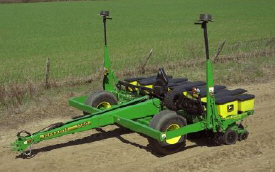 1785 Rigid Frame Planter
1785 Rigid Frame Planter
The 1785 Rigid Frame Planter features a 7.6-cm x 17.8-cm (3-in. x 7-in.) front frame for fertilizer, a 17.8-cm x 17.8-cm (7-in. x 7-in.) rear frame, and heavy-duty drop-axle lift system.
Large-frame carrying wheels provide good flotation and are located in front of the 17.8-cm x 17.8-cm (7-in. x 7-in.) frame tube to maximize planting unit location. The 1785 is a versatile planter recommended for conventional, reduced-till, double-crop, and no-till planting conditions.
Alternating row-units are equipped with long parallel arms so they are offset to the rear of the machine approximately 17.8 cm (7 in.). This alternate spacing permits trash and soft soil to flow easily through the narrow row spacings of 38.1 cm, 45.7 cm, and 48.3 cm (15 in., 18 in., and 19 in.). All rows are in line for easy bulk seed filling.
NOTE: Firm ground conditions are recommended for best planter operations.
1785 available sizes and configurations
Frame size |
Row combinations |
Row spacing |
6-Row narrow |
6-Row narrow |
76.2 cm (30 in.) |
11-Row solid* |
38.1 cm (15 in.) | |
| *Also plants six rows at 76.2-cm (30 in.) | ||
8-Row narrow |
8-Row narrow |
76.2 cm (30 in.) |
15-Row solid* |
38.1 cm (15 in.) | |
| *Also plants eight rows at 76.2 cm (30 in.) | ||
Transportability
The transport dimensions for the 1785 Rigid Frame Planter are as follows:
Model |
Transport width |
Transport height* |
| 6/11Row30/38 cm (15 in.) | 4.95 m (16.25 ft) | 3.35 m (11 ft) |
| 8/15Row30/38 cm (15 in.) | 7 m (22 ft, 10 in.) | 3 m (9.75 ft) |
| *Height measured with 18.4R-46 rear tires on tractor | ||
Fertilizer capabilities
The 1785 Rigid-Frame Planter may be equipped with liquid or granular fertilizer systems. On single-disk fertilizer openers, an alternate downforce spring (A50733) is recommended in tough, conservation conditions. On the 8Row30 Planter, due to frame limitations, the single-disk fertilizer openers on rows four and five can only be set 12.7 cm to 15.2 cm (5 in. to 6 in.) off the row center line.
SeedStar™ 2 monitoring system
Integrated innovation is what operators will appreciate with the SeedStar 2 monitoring system and GreenStar™ 2 Display. An increasing number of acres combined with rising seed costs drive the need to easily understand planter functions and monitor performance. It is all about making every seed count and that is what SeedStar 2 delivers.
The SeedStar 2 monitoring system is a full-feature, color, seed population monitor used in conjunction with the GreenStar family of displays. SeedStar 2 is compatible with the GreenStar 2 1800 and 2600 Displays, GreenStar 3 2630 Display, the Gen 4 4200 CommandCenter™ Display, the Gen 4 4600 CommandCenter Display, the 4240 Universal Display, and the 4640 Universal Display. SeedStar 2 is not compatible with the Gen 4 Extended Monitor. Conveniently, SeedStar 2 planting functions are fully integrated with the full spectrum of Precision Ag Technology applications—guidance, coverage maps, and field documentation can be shown all on one display.
When a SeedStar 2 system is used on a planter, there is no need for a ComputerTrak™ monitor. All vital planting information is displayed in one central, easy-to-read location.
SeedStar 2 features
 SeedStar 2 full-screen planter run page
SeedStar 2 full-screen planter run page
SeedStar 2 is a user-friendly system that has retained all the valued features of SeedStar and incorporated the next generation of enhancements. For example, on-screen color indicators show drive engagement/disengagement status. In addition, three color planter-at-a-glance bars (black, orange, or red) visually inform the operator of row population status.
Not only does SeedStar 2 incorporate the use of color, it also utilizes an intuitive icon and folder based operator interface. Icons are easy to understand across many languages and reduce the need for text. Icons for planter main run page, planter setup, seed/crop setup, totals, and diagnostics are located in the soft-key region of the display. Setup is performed by selecting the appropriate icon and then choosing the tabs to enter/select information.
The SeedStar 2 monitor offers all of the features and functionality of the ComputerTrak 350 monitor and much more. SeedStar 2 monitors the following planter functions:
- Row population/spacing
- Row failure
- Average population (entire planter and by variable-rate drive [VRD] motor section)
- Vacuum level
- Fertilizer pressure
- Acre counter
- Total acreage
- Tractor speed
In addition, planter operational information is available within the SeedStar 2 monitor system. Such operational information includes population charts, seed disk vacuum settings, and setting recommendations for the piston pump liquid fertilizer system.
All SeedStar 2 systems have the capability, through a single controller, to perform both the seed monitoring and variable rate drive functions. SeedStar 2 monitoring is required for VRD population control. Even though the planter may not be equipped with SeedStar 2 VRD, the SeedStar 2 monitoring system is available and will allow for future installation of VRD.
SeedStar 2 enhancements
 SeedStar 2 half-screen planter run page
SeedStar 2 half-screen planter run page
 SeedStar 2 showing half-width disconnect status
SeedStar 2 showing half-width disconnect status
The SeedStar 2 enhanced planter features include:
- GreenStar 2 display integration – eliminates the need to operate the GreenStar 2 2600 Display in the original GreenStar monitor mode or the use of dual displays.
- User-friendly, intuitive icons
- Half- or full-screen run page
- On-screen, color drive status – a quick glance at the display tells the operator if the half-width disconnect is engaged or disengaged.
- Three-color planter-at-a-glance population bar – a black bar indicates that population is close to target and within established limits; orange shows the population is above/below the alarm set point; and red signals the population is out of operating range or is not planting.
- Three-piece, color VRD indicator – each piece of the VRD gear pie turns green when the wheel motion sensor is active, planter is lowered, and drives are engaged.
SeedStar monitoring original features
SeedStar 2 retains all those SeedStar features that producers value and have come to expect:
-
Planter at a glance – allows operator to view relative population levels of all rows on one screen.
-
Automatic valve calibration – with the SeedStar VRD, this is now completed automatically. There is no longer a need to manually calibrate the hydraulic valves.
-
Increased population updates – SeedStar will now update population levels once a second at planter start up then approximately once every three seconds.
-
Mapping of actual seed rates – When combined with Field Doc™ system, actual and target seeding rates can now be mapped in APEX™ software.
-
Reprogrammable utilizing controller area network (CAN) via Service ADVISOR™ diagnostics system.
-
Improved diagnostics/event recorder – on SeedStar VRD planters, additional diagnostic information is available, as well as an event recorder to capture system performance data at a specific point in time.
-
Ability to run motors at different population levels – on SeedStar VRD, operators running multiple motor systems can run each motor at a different speed, allowing different population levels within a planter.
-
User-configurable high fertilizer pressure alarm – allows the operator to be warned when fertilizer pressure reaches a specific level.
-
Automatic quick-start for SeedStar VRD – the operator no longer needs to press the quick-start button on end row turns to resume planting.
-
Automatic tractor speed source selection – when equipped with an 8000/9000 Series Tractor, the system selects the radar speed or allows for manual speed input selection.
Row cleaner options to meet residue management needs
Crop yields have increased through the years along with the amount of residue left in the field after harvest. At the same time, tillage practices have changed, including different tillage operations which maintain large amounts of surface residue, and even no-till practices. Row cleaners are an essential tool in managing this increased amount of residue.
John Deere seeding group offers a variety of row cleaner options to meet the needs of a producer's operation. Compatibility varies by model, row spacing, and other planter equipment.
Screw-adjust, unit-mounted row cleaner
 Screw-adjust, unit-mounted row cleaner
Screw-adjust, unit-mounted row cleaner
The screw-adjust, unit-mounted row cleaner is mounted directly to the face plate of the row-unit, placing the ground engaging components just in front of the row-unit opener blades and depth gauge wheels. This close proximity allows the gauge wheels to control the depth of the row cleaner as well as the row-unit. This compact design also allows greater compatibility with fertilizer openers and other planter attachments.
SharkTooth® wheels are standard equipment on the unit-mounted row cleaner. The swept-tooth design of the wheel provides a clear path for the row-unit openers while resisting residue buildup on the wheel. The screw adjustment knob is accessible through the top of the parallel arms, providing convenient access for adjustments. The row cleaner can be adjusted in 1.6-mm (1/16-in.) increments, providing plenty of flexibility to meet the needs of changing conditions.
Floating row cleaner with unit-mounted coulter
 Floating row cleaner with unit-mounted coulter
Floating row cleaner with unit-mounted coulter
The floating row cleaner allows a row cleaner to be used in conjunction with a unit-mounted coulter. This combination is often desired in heavy residue loads and reduced tillage planting conditions. The row cleaner provides a clear path for the row-unit, while the unit-mounted coulter helps penetrate tough soil conditions.
Accommodating the unit-mounted coulter means the residue wheels are farther forward from the row-unit face plate than in the case of the screw-adjust row cleaner. To maintain performance, this row cleaner has the capability to float above a defined minimum depth.
Standard depth-gauging bands on the wheels allow the row cleaner wheels to float independently of the row-unit openers, allowing both to perform in varying terrain. The unit may also be set in a fixed position by simply pinning through the bracket if desired. This row cleaner also features SharkTooth wheels as standard equipment.
The floating row cleaner and unit-mounted coulters are available on many planters as factory-installed equipment. As compatibility and details vary by model, review the following links for information on specific planter models.
NOTE: Screw-adjust row cleaners are not compatible with MaxEmerge™ 5e row-units with long parallel arms.
NOTE: DB models have the option for either unit-mounted coulter, screw-adjust row cleaners, or pneumatic row cleaners (only compatabile with MaxEmerge 5e or equipped ExactEmerge™ models). The DB60T is only available with a less row cleaner option.
SharkTooth is a trademark of Yetter Manufacturing, Inc.
Granular fertilizer systems
Granular fertilizer hopper and transmission
 Granular fertilizer hopper and opener
Granular fertilizer hopper and opener
Granular fertilizer is available for 1755, 1775, and 1785 Planters. Fertilizer hoppers/tanks and selected other equipment may not be installed to facilitate shipping. Fertilizer attachments place fertilizer only on 76.2-cm, 91.4-cm, or 96.5-cm (30-in., 36-in., or 38-in.) spacings. Some planter frame and row spacing combinations result in the opener offset 10.1 cm to 15.2 cm (4 in. to 6 in.) from the centerline of the Tru-Vee opener.
Hoppers hold approximately 249.5 kg (550 lb) of fertilizer for longer operating time between fill-ups. One hopper feeds two rows. Hopper lids provide a large opening for fast filling with less spillage. Hoppers pivot for easy dumping and cleaning.
The transmission (two on 1775) has 24 sprocket combinations in consistent 6 percent increments to allow operators to apply fertilizer at the desired application rate. Depending on which auger is selected, a wide range of fertilizer rates can applied from 52.7 kg/ha (47 lb/acre) to 803.7 kg/ha (717 lb/acre). It requires openers or a surface application bracket.
Augers for granular fertilizer system
Low-, regular-, or high-rate feed augers are required to complete the granular fertilizer system. Augers move fertilizer from the fertilizer boxes to the opener. Regular- or high-rate augers are matched with the opener style selected and are available as a factory-installed option or as an attachment for field conversion. Low-rate augers are only available as an attachment for field conversion.
For 76.2-cm (30-in.) rows, the approximate rate of application is as follows:
-
Low-rate augers – 52.7-139 kg/ha (47-124 lb/acre)
-
Regular-rate augers – 105.4-533.5 kg/ha (94-476 lb/acre)
-
High-rate augers – 183.8-803.7 kg/ha (164-717 lb/acre)
For 96.5-cm (38-in.) rows, the approximate rate of application is as follows:
-
Low-rate augers – 41.5-208.5 kg/ha (37-186 lb/acre)
-
Regular-rate augers – 82.9-418.1 kg/ha (74-373 lb/acre)
-
High-rate augers – 124.4-626.6 kg/ha (111-559 lb/acre)
NOTE: Weight metered may vary from that indicated because the fertilizer attachment will meter by volume not by weight and because of differences in fertilizer density.
1755 and 1785 granular fertilizer openers
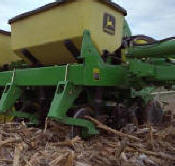 Granular fertilizer opener
Granular fertilizer opener
Frame-mounted, double-disk openers and frame-mounted, single-disk openers for granular fertilizer are available on the 1755 and 1785 Planters. The frame-mounted, single-disk opener is available with a regular spout or cast spout. Fertilizer openers place the granular fertilizer into the soil for maximum plant uptake and are adjustable. Single-disk fertilizer openers are required for no-till, but are also suitable for conventional and reduced tillage. Double-disk fertilizer openers should only be used in conventional and reduced tillage conditions.
-
Single- and double-disk openers are compatible with frame-mounted coulters.
-
Single-disk opener with cast spout is recommended for all soil conditions because it keeps soil from flowing into the furrow before fertilizer is delivered.
-
The gauge wheel on single-disk openers will help gauge fertilizer application depth and minimize soil disruption.
-
On 1755 8Row30 Planters, due to frame limitations, the granular fertilizer systems with single-disk openers can place fertilizer no closer than 12.7 cm to 15.2 cm (5 in. to 6 in.) to the seed furrow on rows 4 and 5.
1770 granular fertilizer openers
Frame-mounted, single-disk fertilizer openers with cast spout are utilized on the 1775 12Row30 Planter. These openers are ideal for both conventional and no-till. The openers are adjustable to place the fertilizer in the soil next to the seed furrow for ideal nutrient placement and maximum plant uptake. A single gauge wheel allows the opener to follow the contour of the ground for ideal fertilizer depth placement. Single-disk fertilizer openers are compatible with frame-mounted coulters.
Granular chemical application systems
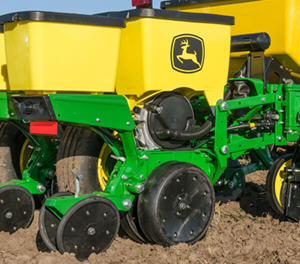 56.4-L (1.6-bu) box with granular chemical option
56.4-L (1.6-bu) box with granular chemical option
Today's planter owners depend on chemicals to control crop pests such as insects or weeds.
MaxEmerge™ 5 planters with 56.4-L (1.6-bu) seed hoppers are available with a variety of granular chemical application attachments that allow opearors to apply insecticide only, herbicide only, or insecticide and herbicide at the same time.
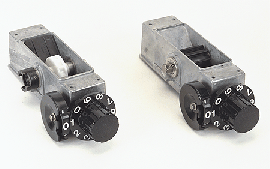 Roller meter and fluted meter
Roller meter and fluted meter
There are two different types of rollers available for the chemical meter.
-
The meter/roller (on the left) features a white plastic cupped meter roller. It is base equipment for all chemical applications.
-
Application rates of up to 226.8 g (8 oz) per 304.8 m (1000 ft) are possible.
-
The conventional fluted meter roller (on the right) is available through service parts. It can apply rates up to and greater than 226.8 g (8 oz) per 304.8 m (1000 ft).
Of the two meter rollers, the cupped roller will cover about 95 percent of producer chemical application needs. The cupped roller/meter will reduce chemical leakage on the end rows and in transport.
These features are common to all granular chemical application attachments:
- Large polyethylene hopper holds 31.8 kg (70 lb) of insecticide or herbicide (15.9 kg [35 lb] each when used together).
- Hoppers equipped with single meters are molded with a sloping floor/side for good runout of chemicals. Hoppers equipped with dual chemical meters do not have the sloping floor design.
- Single meter hoppers cannot be converted to dual meter chemical operation; the sloping floor design will not accept the box divider.
- Large detented knob(s) have easy-to-read digits for quick, accurate settings.
- Lid is attached to hopper to ensure chemical is always enclosed during use.
- Individual manual row-unit shutoff is standard equipment.
- Adjustable orifice in chemical meter determines chemical delivery rate. Rotating fluted rotor ensures there is always chemical material above the orifice.
- Plastic metering components resist corrosion.
A unique drive system automatically engages and disengages for each hopper. There is also an easy-to-reach push/pull knob for disengaging the drive when it is desirable to discontinue chemical application.
The Pro-Shaft™ drive driven granular chemical system is ideal for fields that have high levels of residue or where a unit-mounted coulter or row cleaner is used. The system performs well in high residue and damp soil conditions due to the lack of chains and sprockets.
NOTE: The Pro-Shaft drive will not shut off with RowCommand™ system because it is driven directly off of the hex shaft. The chain drive system will disengage with the seed meter when using the RowCommand system.
John Deere liquid fertilizer system delivers row-to-row accuracy
Block manifold delivery system
 Block manifold distribution
Block manifold distribution
Delivering consistent and accurate fertilizer rates to each row is critical with any liquid fertilizer delivery system. The John Deere liquid fertilizer system utilizes 12-port block manifolds to equally distribute flow to the opener or in-furrow method of application. Liquid is distributed to each row through a 7.6-mm (0.3-in.) hose.
There are check valves at each row to ensure the system remains primed and flow stops immediately when planter is lifted. An orifice is located in-line and provides the restriction needed to achieve desired system pressure for excellent rate accuracy.
This delivery system will operate between 103.4 kPa and 620.5 kPa (15 psi and 90 psi), depending on the orifice size and rate. System pressure should not exceed 689.5 kPa (100 psi). Four orifice sizes allow operators to achieve a variety of rates all with optimal system performance and row to row accuracy. See rate chart below for model by model minimum and maximum application rates.
An 80-mesh washable screen is in place between the tank and the pump. It is essential to have this screen (AA40216) and associated fittings in place ahead of the fertilizer pump, even if not using a factory tank and quick-fill system. This screen is utilized to catch any blocks in the system caused by liquid fertilizer impurities. It is not recommended to use the 50-mesh screen.
 80-mesh screen and fittings
80-mesh screen and fittings

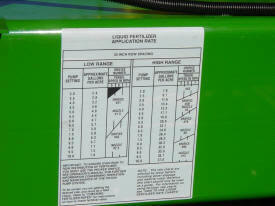 Fertilizer rate chart located on planter
Fertilizer rate chart located on planter

Refer to this chart or the operator’s manual for fertilizer rate settings.
Model |
Maximum rate, |
Minimum rate, |
1705, 1715, 1725, 1755, 1765, 1775NT 12R, 1775NT 16R - 76 cm (30 in.) |
351.7 (37.6) |
22.5 (2.4) |
1705, 1715, 1755 - 91.4 cm (36 in.) |
292.8 (31.3) |
18.7 (2.0) |
1705, 1715, 1755 - 96.5 cm (38 in.) |
277.8 (29.7) |
17.8 (1.9) |
1705, 1715 - 101.6 cm (40 in.) |
263.8 (28.2) |
16.8 (1.8) |
1785 - 76.2 cm (30 in.) |
391 (41.8) |
24.3 (2.6) |
1785 - 91.4 cm (36 in.) |
325.5 (34.8) |
20.6 (2.2) |
1785 - 96.5 cm (38 in.) |
308.7 (33.0) |
19.6 (2.1) |
1775NT 24R Fixed-rate pump |
290 (31.0) |
29.9 (3.2) |
1795 |
265.7 (28.4) |
30.9 (3.3) |
DB44 24R22 |
187.1 (20.0) |
37.4 (4.0) |
DB60 24R30 |
131 (14.0) |
28.1 (3.0) |
DB60 47/48R15 |
131 (14.0) |
46.8 (5.0) |
DB60 36R20 |
131 (14.0) |
37.4 (4.0) |
DB66 36R22 |
112.2 (12.0) |
37.4 (4.0) |
DB80 48R20 |
93.5 (10.0) |
37.4 (4.0) |
DB88 48R22 |
93.5 (10.0) |
37.4 (4.0) |
DB90 36R30 |
74.8 (8.0) |
28.1 (3.0) |
DB80 32R30 |
74.8 (8.0) |
28.1 (3.0) |
DB120 48R30 |
65.5 (7.0) |
28.1 (3.0) |
NOTE: 1.02-mm (0.04-in.) yellow orifices and 1.8-mm (0.07-in.) black orifices are included with this system from the factory. For producers wanting to apply higher or lower application rates, two additional orifice sizes are available through Service Parts; 0.76-mm (0.03-in.) green (A91474) and 25.4-mm (1-in.) grey (A91478). Refer to rate charts in the operator’s manual or decal for details.
Fertilizer pump and opener options
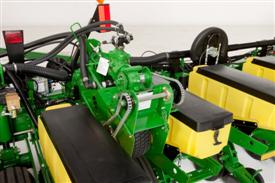 Fixed-rate CDS-John Blue Company® piston pump
Fixed-rate CDS-John Blue Company® piston pump

This liquid fertilizer delivery system is compatible with the fixed-rate pump. The system can be ordered with openers or with an in-furrow applicator.
Flow monitor
If producers want to add a visual flow monitor to this system, John Deere has formed an allied agreement with CDS-John Blue to meet this need. Please contact CDS-John Blue for flow monitor options.
CDS-John Blue Company, Division of Advanced System Technology, Inc.
PO Box 1607, Huntsville, AL 35807
Tel: 800-253-2583, 256-721-9090
Fax: 256-721-9091
Email: info@cds-johnblue.com
www.cds-johnblue.com
CDS-John Blue Company is a trademark of Advanced Systems Technology, Inc.
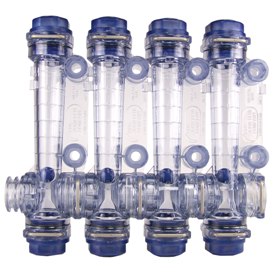 CDS-John Blue Visa Gage II liquid flow-rate monitor
CDS-John Blue Visa Gage II liquid flow-rate monitor
Features
SeedStar™ 4HP monitoring system
SeedStar 4HP is designed to optimize the in-cab monitoring experience exclusively on the Gen 4 4600 CommandCenter™ display or 4640 Universal Display for growers with ExactEmerge™ planters and MaxEmerge™ 5e planters model year 2018 and newer. With SeedStar 4HP, operators will easily see key planter information with customizable run pages, zoom functionality, and simultaneous graph and performance measurements. SeedStar 4HP is included in base on all model year 2018 ExactEmerge and MaxEmerge 5e planters.
Features overview:
- View multiple planters' at-a-glance bar charts simultaneously
- Three default planter run pages show key planter functions in easy-to-view layouts
- Highly configurable run pages allow SeedStar modules to be customizable
- Zoom feature allows quick row-by-row detailed information
- View dual bar graphs to see multiple planter details at one time
- SeedStar application to make adjustments to planter functions
- Simplified setup through the work set-up page
- Custom rates allow up to six different rates across 48 rows
- The SeedStar 4HP monitoring system requires the Gen 4 4600 CommandCenter or 4640 Universal Display. These displays allow the operator to benefit from the updated interface, enhanced processing speeds, and easy setup (learn more here).
SeedStar 3 HP conversion to SeedStar 4HP with mobile row-unit runoff aftermarket for field conversion kits
Growers who are currently running model year 2017 planters, model year 2017 and newer retrofit kits, or model year 2017 and newer custom-built planters with the SeedStar 3 HP monitoring system can upgrade to the SeedStar 4HP monitoring system with mobile row-unit runoff. The attachment part, AA100382, is software only. The Gen 4 display software version will need to be 19-1 or newer and will require planter apps. Follow the mobile runoff ordering and software push guide below for ordering and installation. Retrofitted planters and custom-built planters will also require the John Deere Connect Mobile kit, 0048PC, from the Precision Ag Technology Price Pages and wiring harness AA83662 to enable the mobile row-unit runoff feature. Please reference Parts Advisor and CCMS Solution 105181 for model-specific mounting brackets. SeedStar 4HP requires the Gen 4 4600 CommandCenter™ v2 display or 4640 Universal Display.
Default planter run pages
 Planter summary default run page
Planter summary default run page
 Planter overview default run page
Planter overview default run page
 Planter details default run page
Planter details default run page
Three default run pages show key planter functions in different views to give fast and easy access to important planter information.
Custom run pages
 Customizable run pages
Customizable run pages
There are customizable run pages that allow the operator to build pages that fit their operation with different modules, like the example shown above.
Zoom functionality
 Zoom feature showing a group of rows
Zoom feature showing a group of rows
 Zoom feature showing a single row
Zoom feature showing a single row
The zoom feature allows the operator to touch a section or row of the planter and get detailed information quickly.
Dual bar graphs
 Dual bar graph showing singulation and population simultaneously
Dual bar graph showing singulation and population simultaneously
Dual bar graphs allow operators to view multiple planter details at one time.
SeedStar application page
 SeedStar application run page
SeedStar application run page
In the SeedStar application, many adjustments can be made, including manually activating section control. SeedStar 4HP allows up to 48 individual row sections. There are several setup features such as crop, seed disk, number of rows being planted, population alarms, and limits. Seed rates can be modified, electric power generation (EPG) can be turned on or off, vacuum can be adjusted, and the fill and purge functions can be used from the SeedStar application. Frame control, as well as diagnostics and calibrations, can be accessed at the bottom of the screen.
Settings Manager in SeedStar 4HP
 Settings Manager screens
Settings Manager screens

Reduce set-up time between changing crops or field conditions by recalling saved settings used previously with Settings Manager, included with every SeedStar 4HP system. This feature allows saving and recalling planter and tractor settings for optimum performance in different conditions.
Settings Manager can be used to save all of the adjustment and inputs associated to a particular crop or condition. An example would be to store all population rates, downforce pressure, row cleaner adjustments, and closing wheel settings for planting corn and storing a separate, unique set of adjustments for soybeans. In addition, Settings Manager stores tractor settings such as selective control valve (SCV) flow and detents, infinitely variable transmission (IVT™) settings, eco modes, and more.
Custom rates in SeedStar 4HP
 Variety set-up page
Variety set-up page
 Rate set-up page
Rate set-up page
 Group rate set-up page
Group rate set-up page
Custom rates allow for individual row population control and row-by-row documentation where up to six different rates can be assigned across an up to 48-row planter. This allows growers interested in planting seed corn with ExactEmerge or MaxEmerge 5e the capability to assign specific populations to male and female rows for planting. This feature can also be used to create tram lines or other applications where custom rates by row are needed.
NOTE: Individual rates are tied to varieties, so each individual rate needs a unique variety name.
Compatibility
| SeedStar 4HP compatibility | |
| Planters | All models ordered with ExactEmerge or MaxEmerge 5e row-units NOTE: Retrofit kits are equipped with SeedStar 3HP only, but can be upgraded by purchasing part number AA100382. |
| Displays | Gen 4 4600 CommandCenter equipped with Version 2 Processor or 4640 Universal Display Dual-display mode is compatible with mid model year 2019 planter software. |
| Active Implement Guidance (AIG) | Compatible with SeedStar 4HP on Gen 4 displays with VT mode and required activations and subscriptions |
| AutoTrac™ Implement Guidance | Not compatible |
| AutoTrac Turn Automation | Not compatible |
Additional information
For additional information on feature functionality on the Gen 4 Display, visit the links below:
YouTube is a trademark of Google LLC.
Easy Fold

Easy Fold is a feature of SeedStar™ 4HP for MaxEmerge™ 5e row-units and ExactEmerge™ row-units equipped on 1775NT and 1795 Planters with a 2-point hitch or DB Planters. This integrated solution replaces the frame-folding box like the manual fold option in SeedStar 3 HP, and it has enhanced the process by controlling and automating the selective control valves (SCVs).
The one-operation fold reduces the need for training inexperienced operators by sequencing the process correctly and reduces time spent folding and unfolding. By utilizing implement automation, the hitch will be controlled by the planter during the fold cycle. Lining up the draft tube to the wing hooks is automated through this process, reducing operator tasks. On DB models, Easy Fold simplifies the folding process functions to one SCV. A manual process is available when needed.
A manual fold option is available from the frame control page on the display for non-compatible or non-equipped tractors or planters. The manual control function is accessible from each step of the Easy Fold process, as shown below.
 Manual control option on SeedStar 4HP
Manual control option on SeedStar 4HP
 Start screen for Easy Fold
Start screen for Easy Fold
 Screen with Easy Fold enabled
Screen with Easy Fold enabled
 Screen with Easy Fold in process
Screen with Easy Fold in process
 Easy Fold completed screen
Easy Fold completed screen
| Easy Fold compatibility | |
| Tractors |
|
| Activation | 2-point hitch equipped planters with Easy Fold require Tractor Implement Automation activation available from the StellarSupport™ portal. This activation is tractor PIN specific and non-transferable. Included in base on model year 2018 compatible tractors. See instructions below. |
| Planters | 1775NT and 1795 with 2-point hitch and DB Planters, equipped with ExactEmerge or MaxEmerge 5e row-units |
| Display | Gen 4 4600 CommandCenter™ Display or 4640 Universal Display |
NOTE: Included in base with ExactEmerge equipped compatible planters. Optional equipment on MaxEmerge 5e equipped compatible planters.
Tractor Implement Automation activation instructions
Use these instructions to download the Tractor Implement Automation activation code at no cost.
- Go to https://www.deere.com/en/stellarsupport/ or https://www.deere.ca/en/stellarsupport/
- Click Product Activation.
- Click Product Activation.
- Select Tractor Automation – Manage Product.
- Add or select existing tractor from list.
- Select the Activate button.
- Select Add Manufacturers drop down menu.
- Select Tractor Implement Automation – John Deere.
- Select Continue – Tractor Implement Automation – John Deere selected.
- Accept the Terms and Conditions.
- Select Finish.
- Take note of the code for use display.
- On the Gen 4 4600 CommandCenter Display or 4640 Universal Display select System, Software Manager.
- Select Activations, then Enter Code from John Deere Stellar Support.
- Enter activation code into the display in the tractor.
- Press next after activating Tractor Implement Automation.
- Take note of the activation code and press OK.
- The Tractor Implement Automation activation will appear the Software Manager screen.
NOTE: Prior to the 18.1 software release, the activation will be shown as “Unknown Implement 1” with a baler icon.
YouTube is a trademark of Google LLC.
Increase job performance when planting and spraying
 Connect Mobile comparison map lets users compare two quality layers at once for planting and spraying
Connect Mobile comparison map lets users compare two quality layers at once for planting and spraying
Connect Mobile overview
John Deere Connect Mobile is a solution that utilizes an Apple® iPad® tablet in the cab and helps the operator increase job performance during planting and spraying operations. Connect Mobile documents and displays multiple quality layers, helping the operator monitor and more easily detect problems that can occur during planting and spraying. Connect Mobile also has a common user interface that makes it easy to use between different pieces of John Deere equipment.
Planting attributes
Monitor and document key performance indicators in high-definition map layers and dashboard tiles such as:
- Actual population
- Target population
- Singulation
- Seed-spacing CV
- Applied downforce
- Gauge wheel margin
- Ride quality
- Ground speed
- Variety
Spraying attributes
- Actual rate
- Rate deviation
- Ground speed
- Pressure
In base equipment
Planting
Connect Mobile hardware is factory installed on all model year 2015 and newer planters factory installed with ExactEmerge™ row-units and all model year 2017 and newer planters factory installed with MaxEmerge™ 5e row-units, making it easy to get started with Connect Mobile.
Spraying
Connect Mobile hardware is factory installed on all model year 2018 Sprayers with the 4600 CommandCenter™ display. Producers can also retrofit Connect Mobile on older sprayers with a GreenStar™ 3 2630 Display by installing the sprayer field kit.
Learn more about Connect Mobile in the Field and Crop Solutions section within the Precision Ag Technology product line and how it can improve the quality of a planting and spraying job.
iPad and Apple are trademarks of Apple Inc.
Mobile row-unit runoff
 Row Runoff diagnostic test
Row Runoff diagnostic test
 The test functions from a mobile device
The test functions from a mobile device
 Determine optimum settings without being in the cab
Determine optimum settings without being in the cab
The first day of planting season can be as productive as the last with mobile row-unit runoff. The mobile row-unit runoff activation on the planter main controller (PMC) allows operators to make adjustments to maximize row-unit performance from a mobile device at the rear of the planter for both preseason and in-season use - all enabled through the PlanterPlus™ app.
Mobile row-unit runoff allows growers to perform test-stand functions from a mobile device connected to the planter.
The row runoff test provides complete diagnostic checks both preseason and in season. With the row-unit runoff test, the operator can make adjustments from the mobile device, including vacuum pressure, to determine the optimum meter and vacuum settings. This app functionality will help avoid making trips to the cab while validating meter performance.
During preseason planter inspections and set up, utilize the meter performance test to validate meter accuracy, similar to a test stand without leaving the farm. Test all systems on the planter, not just the meter, providing confidence that all planter systems are ready to plant. Reports are generated from the test providing information the operator can save and send for future reference.
Before heading to the field, the operator will benefit from knowing the best row-unit and vacuum settings for each variety selected to plant that spring.
Watch this video to see mobile row-unit runoff in action.
Mobile row-unit runoff will work with any model year 2015 or newer ExactEmerge™ or MaxEmerge™ 5e equipped planter. Mobile row-unit runoff can be added with attachment AA93169.
For model year 2018 and newer ExactEmerge planters, mobile row-unit runoff is included in base equipment. For model year 2018 and newer MaxEmerge 5e planters not equipped from the factory, mobile row-unit runoff can be added with attachment AA93169. A mobile row-unit runoff and Easy Fold package can be added with attachment AA97849 (only available with 1775NT and 1795 Planters with a 2-point hitch and model year 2019 and newer DB Planters with Gen 4 based frame folding).
NOTE: Mobile runoff utilizes PlanterPlus app available on select iPad® tablets, iPhone® smartphones, and Android™ devices.
Mobile row-unit runoff and Easy Fold aftermarket for field conversion kits
The below software bundles include the functionality explained above for machines not ordered with the feature from the factory. Compatible machines include all the necessary sensors and harnesses needed to make the feature function. The attachment part is software only. Follow the mobile runoff ordering and software push guide below for ordering and installation.
SeedStar™ 3 HP conversion to SeedStar 4HP with mobile row-unit runoff aftermarket for field conversion kits
Growers who are currently running model year 2017 planters, model year 2017 and newer performance upgrade kits, or model year 2017 and newer custom built-planters with the SeedStar 3 HP monitoring system can upgrade to the SeedStar 4HP monitoring system with mobile row-unit runoff. The attachment part, AA100382, is software only. The Gen 4 display software version will need to be 19-1 or newer and will require planter apps. Follow the mobile runoff ordering and software push guide below for ordering and installation. Performance upgraded planters and custom-built planters will also require the John Deere Connect Mobile kit, 0048PC, from the Precision Ag Technology Price Pages and wiring harness AA83662 to enable the mobile row-unit runoff feature. Please reference Parts Advisor and CCMS Solution 105181 for model-specific mounting brackets. SeedStar 4HP requires the Gen 4 4600 CommandCenter™ v2 display or 4640 Universal Display.
Mobile runoff ordering and software push guide
iPad and iPhone are trademarks of Apple Inc. Android is a trademark of Google LLC.
Downforce system options

Heavy-duty adjustable downforce springs
 Heavy-duty adjustable downforce spring
Heavy-duty adjustable downforce spring
Planter row-unit downforce is an important factor to ensure consistent and proper depth control. The heavy-duty adjustable downforce feature provides up to 181.4 kg (400 lb) of downforce. There are four settings available to allow the operator to choose the amount of downforce required for the condition: 0 kg (0 lb), 56.7 kg (125 lb), 113.4 kg (250 lb), and 181.4 kg (400 lb).
Compatibility: 1705, 1715, 1725, 1735, 1755, 1765, 1765NT, 1775 Flex, and 1785
Standard pneumatic downforce system
Pneumatic downforce provides convenient, simple adjustment of downforce for the whole planter from one location. The amount of downforce applied is infinitely adjustable from 0 to 181.4 kg (0 to 400 lb). Pneumatic downforce provides more consistent downforce throughout the range of row-unit travel than mechanical spring downforce systems.
Features include:
- 9.5-mm (3/8-in.) air delivery line instead of the 6.4-mm (1/4-in.) line used on model year 2010 and older planters.
- Air compressor assembly increased duty cycle. With this compressor, it provides a 47 percent increase in maximum air flow delivery compared to the prior air compressor.
- Pneumatic air bags with 9.5-mm (3/8-in.) air line inlets that have greater durability.
 Pneumatic downforce spring
Pneumatic downforce spring
Each row-unit has a single rubber air bag located between the parallel arms. The air bags are hooked in parallel so that air can be added or released from all rows at once from one location.
The individual pneumatic downforce air bag assemblies, air compressor units, and 9.5-mm (3/8-in.) delivery lines are also available as an attachment for field conversion.
 Pneumatic downforce compressor and gauge
Pneumatic downforce compressor and gauge
An improved compressor is used to charge the pneumatic system. This compressor can be located on the planter frame or in the tractor cab if desired. A gauge at the compressor indicates the amount of downforce being applied.
From the factory, integral planter models with pneumatic downforce will have an improved air compressor assembly with an in-cab mounting bracket, except for the 1725 16-row and 1725 Central Commodity System (CCS™) twin-row planters, which will have the air compressor assembly mounted on the planter frame. For drawn planter models, the 1755, 1765, 1765NT, 1775 Front-Fold, and 1785 Drawn Planters will have the air compressor assembly installed either on the outer hitch or wing frame members when the pneumatic downforce system is installed.
Base equipment on: 1705, 1715, 1725, 1735, 1755, 1765, 1765NT, 1775 and 1785.
Integrated pneumatic downforce system
The functional features of the integrated system are the same as the standard pneumatic system, explained above, with the addition of control through the GreenStar™ display.
System control with the GreenStar display
 Pneumatic downforce control in GreenStar 2 Display
Pneumatic downforce control in GreenStar 2 Display
 Air compressor mounted on 1775NT outer hitch
Air compressor mounted on 1775NT outer hitch
On 1725 16-row, 1725 CCS TR, 1775NT, 1775NT CCS, 1795, DR, and DB Series Planter models, the air compressor will be mounted on the outer hitch or frame assembly. Since the air compressor assembly is mounted on the outer hitch (as noted in the picture above) or frame, adjustments for row-unit downforce and related system pressures will be made electronically with the GreenStar display.
When adjusting the amount of row-unit downforce using the GreenStar display, the operator will select the amount of downforce (kg [lb]) to be applied across the planter. Depending on the soil conditions at hand, the operator might need to adjust the relative amount of row-unit downforce being applied during the planting operation. The integrated pneumatic downforce controls within the GreenStar display will only allow for set-point operation and not automatic control as the planter is operating in different soil conditions. The pneumatic downforce system does not have the capability to automatically adjust downforce.
On-board air storage
 Onboard air storage installed on 1775NT 24R30
Onboard air storage installed on 1775NT 24R30
The 1725 16-row, 1725 CCS TR, 1775NT, 1775NT CCS, 1795, DR, and DB Series planters will have onboard air storage to increase the overall response time when making a row-unit downforce adjustment from the GreenStar display. The onboard air storage is comprised of a 18.9-L (5-gal.) storage tank with valve assembly.
Base equipment on: 1725 CCS, 1725 16-row, 1725T, 1775NT, 1775NT CCS, 1795, DR, and DB Series Planters with MaxEmerge™ 5 row-units. MaxEmerge 5e and ExactEmerge™ equipped planters come with active pneumatic downforce in base.
Active pneumatic downforce
 Active downforce compressor assembly
Active downforce compressor assembly
 Hydraulic motor
Hydraulic motor
A hydraulically driven compressor works with the SeedStar™ 3 HP system and SeedStar XP system to automate downforce control. Just set the row-unit target margin value and the active pneumatic downforce system works automatically. The system will make sure the planter maintains this value, achieving precise soil penetration, and consistent planting depth, without sidewall soil compaction. From the factory, the system is set at 45.4 kg (100 lb) target downforce margin, but may be modified for varying field conditions. This frees the operator from constantly making manual downforce adjustments as conditions change.
This system offers a split-rank control feature for 1795 and DB Split-Row Planters. On split-row planters, active downforce will control the front and rear rows independently. This compensates for differing downforce requirements between the ranks that can be caused by things like different tillage or insecticide attachments and will help maintain an accurate planting depth and consistent margin across all the rows.
Active pneumatic downforce is available as factory installed or as an attachment for field conversion.
SeedStar XP row-unit downforce planter run page
 SeedStar XP downforce planter run page
SeedStar XP downforce planter run page
Active downforce control is integrated into SeedStar XP and SeedStar 3 HP monitoring systems.
Margin is the amount of weight riding on the depth gauge wheels that ensures desired firming of the seedbed as set by the operator.
Once a target margin has been defined, enter the value into SeedStar XP or SeedStar 3 HP and let active downforce do the rest. The system will actively adjust the air pressure in the air bags to maintain a constant margin across the planter. The changes in air pressure will change the amount of downforce placed on the row-unit, compensating and reacting for varying conditions through the field whether it is different tillage practices, soil types, or moisture.
 Downforce and margin example
Downforce and margin example
- A - Margin – amount of additional downforce applied to a row-unit above and beyond what is required for penetration to achieve planting depth. This additional weight will ride on the depth gauge wheels. 54.4 kg (120 lb) + 36.3 kg (80 lb) = 90.7 kg (200 lb) – 68 kg (150 lb) = 22.7 kg (50 lb) of margin
- B - Weight of row-unit - 54.4 kg (120 lb)
- C - Downforce – force that is applied to the row-unit by the air bag circuit - 36.3 kg (80 lb)
- D - Resistance from soil - 68 kg (150 lb)
Hydraulically driven compressor
 Hydraulic motor
Hydraulic motor
 Pneumatic valve
Pneumatic valve
The hydraulically driven air compressor can deliver up to eight times the air flow, allowing for more and faster downforce changes to be made. This more robust design features a 37.8-L (10-gal.) storage tank across all models with active downforce.
At approximately 15.1 L/min (4 gpm), hydraulic demands are low and ties into the machine’s lift and CCS hydraulic circuit so it does not require any additional selective control valves (SCVs). The SeedStar XP and SeedStar 3 HP monitoring systems work with the compressor and valve assembly to regulate air to downforce springs, enabling the active control.
Another feature of John Deere active downforce is the ability for the pneumatic valve to independently control split-rank machines. This system senses the downforce needs from the front and rear ranks separately and independently adjusts air pressures with the dual-rank pneumatic valve when equipped. Active pneumatic downforce requires SeedStar XP or SeedStar 3 HP to enable active control.
Base equipment on: All MaxEmerge 5e and ExactEmerge equipped planter models.
Individual Row Hydraulic Downforce (IRHD)

IRHD has been specifically designed to meet the needs of producers that are looking to adjust to the toughest field conditions and provide maximum yield potential from field to field, season after season. IRHD works as a closed-loop downforce system that reacts quickly on an individual row basis to changing soil conditions supporting increased ground contact, which can lead to improved seed depth consistency. When setting planter downforce margin, the system will apply the needed downforce by row to maintain ground contact. From the factory, the margin will be set at 45.4 kg (100 lb), changes may be required based on varying field conditions.
The system allows operators to maintain gauge wheel ground contact leading to desired seed depth placement. IRHD can adjust five times per second and make adjustments of 45.4 kg (100 lb) in less than a second. The system has a total range of applied downforce from 22.7 kg (50 lb) to 204.1 kg (450 lb) and utilizes the power beyond circuit on the tractor. IRHD is 58 percent faster than the active pneumatic downforce solution. Fast reaction and increased ground contact can lead to improved emergence. With uniform emergence, some studies have shown a yield impact from 5 percent to 9 percent.
IRHD is controlled through the Gen 4 4600 CommandCenter™ Display or 4640 Universal Display with SeedStar 4HP. As shown below, operators can view ground contact or applied downforce using the toggle button.
 IRHD screen showing the ground contact graph
IRHD screen showing the ground contact graph
 IRHD screen showing the applied downforce graph
IRHD screen showing the applied downforce graph
Optional equipment on: 1775NT, 1795, DB, and Orthman custom models with MaxEmerge 5e and ExactEmerge row-units.
Pneumatic closing wheels

Pneumatic closing wheels are compatible with MaxEmerge™ 5e and ExactEmerge™ row-units. They are available on the following models from the factory: 1775NT, 1795, and DB60 models. The pneumatic closing wheels give operators the ability to adjust closing wheels in seconds without leaving the cab of the tractor.
Using the GreenStar™ 3 2630 Display, pneumatic closing wheels can be adjusted to 25 different positions. From the factory the system is setup with two sections, the outer wings and center frame. With this system, producers will see up to a 76 percent increase in consistent force applied at the closing wheel. Consistently applying the correct force at the seed trench is one of the key elements of supporting improved emergence. Studies show potential yield impact on corn from even emergence from 5 percent to 9 percent*.
NOTE: Pneumatic closing wheels can be purchased for existing MaxEmerge 5e and ExactEmerge planters as an aftermarket field kit. Both rubber tire and cast-iron closing wheels are compatible.
Access the pneumatic closing wheels attachment for field conversion (AFC) ordering guide to fit a 1725 CCS, 1775NT, 1795, or DB60 Planter.
*Planting Outcome Effects on Corn Yield: Doerge, Tom, Jeschke, Mark and Carter, Paul
Easy Adjust row cleaners
 Coulter combo row cleaner
Coulter combo row cleaner
 Easy Adjust row cleaner
Easy Adjust row cleaner
Easy Adjust row cleaner and coulter combo provides a pneumatic row tillage solution that is controlled from the seat of the tractor.
Every decision to make an adjustment during spring planting reduces the acres planted per day and can increase or decrease profitability. An adjustment that can be overlooked is row cleaners due to planter size, difficulty to make the adjustment, and varying conditions across fields and time.
 GreenStar™ 3 2630 Display view for row cleaners compatible with SeedStar™ 3 HP
GreenStar™ 3 2630 Display view for row cleaners compatible with SeedStar™ 3 HP
 4600 CommandCenter™ Display and 4640 Universal Display view for row cleaners compatible with SeedStar 4HP
4600 CommandCenter™ Display and 4640 Universal Display view for row cleaners compatible with SeedStar 4HP
With the Easy Adjust row cleaners on ExactEmerge™ planters, operators now have a pneumatic solution to make on-the-go adjustments that is controlled directly from the seat of the cab. They can be raised from the cab as needed with the push of a button for wet areas, waterways, or end rows. For growers using SeedStar 3 HP, the row cleaners are completely integrated into the John Deere GreenStar 3 2630 Display as well as the Gen 4 4600 CommandCenter display or 4640 Universal Display. For growers using SeedStar 4HP, a 4600 CommandCenter display or 4640 Universal Display is required.
The Easy Adjust row cleaners have the capability to save three presets for varying ground engagement based on field conditions. The system is controlled in three sections: at each wing as well as the center (frame or wheel) track rows. The pneumatic lines use air from the active pneumatic downforce compressor, requiring no additional compressor to be installed on the planter. The Easy Adjust row cleaners utilize down and up force air bags. The adjustable air pressure setting for each bag allows the operator to set the ride of the row cleaner depending on the field conditions and the desired results. Making these on-the-go adjustments from tractor cab increases productivity and performance during planting.
For Easy Adjust row cleaner performance upgrade kit options, see the ordering guide.
The row cleaner-only option utilizes parallel linkage to provide the floating action growers require in their fields. Parallel linkage allows for the unit to float up and down in the situation of hills or hard objects. The cleaner and coulter combo does not have parallel linkage, however, the row cleaners have floating rings installed to help provide the same benefits.
The row cleaners utilize the field-proven SharkTooth® design. Row cleaners play a major role in maximizing yield toward uniform emergence, reducing row-unit bounce, and maintaining proper depth. The Easy Adjust row cleaners provide growers with quick and stress-free solutions to customizing the planter in variable field conditions. They are available on ExactEmerge and MaxEmerge 5e equipped planters. They are not integrated into the RowCommand™ feature.
SharkTooth is a trademark of Yetter Manufacturing Incorporated.
Vacuum automation
 Vacuum automation screen
Vacuum automation screen
Vacuum control has been defined. Before vacuum automation, an operator set the vacuum level by adjusting the hydraulic flow through each selective control valve (SCV). Many variables altered the vacuum level while the hydraulic flow stayed constant. This could have resulted in under or over populating, which may have impacted singulation. With vacuum automation, all that needs to be done is set the desired vacuum level and let the monitor do the work of adjusting the hydraulic flow. Should vacuum changes occur, the software in the monitor will fluctuate the SCV flow to achieve the desired vacuum level.
Vacuum automation requires SeedStar™ 4HP monitoring. The system controls SCV flow based on the vacuum pressure sensor. The tractor must be a John Deere with Tractor Electronic Control Unit (TECU) 3 controller area network (CAN) system for this feature to be compatible. The vacuum automation feature will control all vacuum fans if they are on their own SCVs. More vacuum fans make the planter more valuable and easier to operate.
Vacuum automation is not compatible with Interim Tier 4 (IT4) 6R Series Tractors.
RowCommand™ individual-row control system
RowCommand controls seed output
 RowCommand on a MaxEmerge™ 5 row-unit
RowCommand on a MaxEmerge™ 5 row-unit
 RowCommand on a chain drive MaxEmerge 5 row-unit
RowCommand on a chain drive MaxEmerge 5 row-unit
Controlling input costs and improving productivity are key producer requirements today. RowCommand is an effective, integrated John Deere solution designed to meet these intensifying needs. The RowCommand system manages seed output, reduces yield drag, and improves harvest capabilities on all Pro-Shaft™ driven row-units, and chain-driven MaxEmerge 5.
NOTE: Chain-drive RowCommand is only compatible with planters equipped with pneumatic downforce systems. On planters equipped with the heavy-duty downforce springs, potential chain interference may result and is not recommended.
NOTE: Chain-drive RowCommand requires some modification to brackets in order to function with corn finger pickup meters.
NOTE: Pro-Shaft drive RowCommand is compatible on MaxEmerge 5 row-units with vacuum and corn finger pickup meters. For mini-hopper row-units, RowCommand is compatible on vacuum meters only and is not compatible on corn finger pickup meters. Pro-Series™ XP row-units with corn finger pickup meters are not compatible with RowCommand.
RowCommand controls seed output by incorporating individual, low amperage clutches inside the Pro-Shaft and chain-driven gearboxes. Clutches are completely enclosed within the gearbox housing to protect them from the elements and harsh operating conditions.
When power is supplied, either manually or through John Deere Section Control software, clutches disengage the seed meters and seed flow stops. Controlling seed output at individual rows reduces overplanting in point rows and maximizes seed placement when entering/exiting headlands.
Components and operation
 Electronic power modules shown on a 1775NT Planter
Electronic power modules shown on a 1775NT Planter
 RowCommand clutch on MaxEmerge 5 with 105.7-L (3-bu) hopper
RowCommand clutch on MaxEmerge 5 with 105.7-L (3-bu) hopper
RowCommand is a simple and efficient solution to control individual row planting. This system does not utilize air to operate; therefore, no compressor, air lines, or valve modules are required.
RowCommand utilizes low-voltage controller area network (CAN) messaging to signal power to the desired clutches to stop planting or eliminates power to resume planting.
This means very little power is used in normal planting conditions, and in the event a clutch fails electrically, the meter will continue to plant.
The RowCommand system requires the following five basic components to operate:
-
Electric clutches
-
Electronic power modules (EPMs)
-
SeedStar™ 2 monitoring (wedge box/controller)
-
GreenStar™ (GS) display
-
Planter wiring harnesses
Clutches are protected within the sealed Pro-Shaft and chain-driven gearboxes for years of trouble-free operation and simple installation or removal. RowCommand has true individual-row control of up to 16 clutches or sections for planters larger than 16 rows.
Unique to RowCommand, the 16 available control sections can be configured based on operator preferences. For example, on a 1775NT 24-Row Planter, every two rows can be paired together for a total of 12 control sections, or control the outermost eight rows individually and the remaining inner rows paired together for 16 control sections.
While SeedStar with RowCommand has 16 control sections, a minimum of 152.4-cm (60-in.) wide sections are recommended for optimum Swath Control Pro™ solution capabilities. As with other Swath Control Pro products, an SF2 signal is the minimum level of accuracy recommend for operation.
Pro-Shaft drive RowCommand planters
RowCommand is available as a factory-installed option or as an attachment for field conversion attachments for the following Pro-Shaft drive planter models (see chart below).
| Planter model | Row configuration |
| 1725 | 12-row narrow, 12-row wide, and 16-row narrow |
| 1725 Central Commodity System (CCS™) | 16-row narrow |
| 1765 | 12-row narrow |
| 1775 | 12-row narrow |
| 1775NT | 12 row, 16 row, and 24-row narrow |
| 1775NT CCS | 12 row, 16 row, and 24-row narrow |
| 1795 | 12/23 row, 12/24 row, 16/31 row, and 16/32 row |
| 1795 | 24 row, 50.8 cm (20 in.) |
| DB 44 | 24 row, 55.9 cm (22 in.) |
| DB 58 | 32 row, 55.9 cm (22 in.) |
| DB 60 | 36 row, 50.8 cm (20 in.) or 47 row, 38.1 cm (15 in.) |
| DB 66 | 36 row, 55.9 cm (22 in.) |
| DB 80 | 32 row, 76.2 cm (30 in.) or 48 row, 50.8 cm (20 in.) |
| DB 88 | 48 row, 55.9 cm (22 in.) |
| DB 90 | 36 row, 76.2 cm (30 in.) |
| DB 120 | 48 row, 76.2 cm (30 in.) |
| DR (Deere/Orthman™ planter) 16R40 | 16 row, 101.6 cm (40 in.) |
| DR (Deere/Orthman) 18R38 | 18 row, 96.5 cm (38 in.) |
Chain-drive RowCommand planters
In terms of planter compatibility, RowCommand for chain drive is designed for the following planter model configurations equipped with pneumatic downforce systems.
| Planter model | Row configuration |
| 1725 | 12-row narrow, 12-row wide, and 16-row narrow |
| 1765 | 12-row narrow |
| 1775 | 12-row narrow |
| 1775NT | 12 row and 16 row |
| 1775NT CCS | 12 row and 16 row |
| DB 44 | 24 row, 55.9 cm (22 in.) |
Chain-drive RowCommand and heavy-duty downforce
 Chain interference with heavy-duty downforce
Chain interference with heavy-duty downforce
As seen in the image, chain interference may result when operating chain-drive RowCommand on planters equipped with short and long parallel arms and heavy-duty downforce springs.
NOTE: Chain-drive RowCommand is only compatible with planters equipped with pneumatic downforce systems. On planters equipped with the heavy-duty downforce springs, potential chain interference may result and is not recommended.
Chain-drive RowCommand with corn finger pickup meters
 Bracket material removal
Bracket material removal
Due to the design characteristics of the chain-drive RowCommand clutch, some modification to the corn finger pickup meter drive bracket is required. As seen in the picture to the left, some material needs to be removed from the front of the meter drive bracket in order for the chain-drive RowCommand clutch to have sufficient space for installation.
NOTE: Chain-drive RowCommand requires some modification to brackets in order to function with corn finger pickup meters.
RowCommand ordering information
To add RowCommand to a model year 2009 and newer planter model listed above is simple. Pro-Shaft drive attachments for field conversion and chain-drive attachments for field conversion are available by planter model to add the appropriate number of clutches, EPMs, brackets, hardware and row-unit harnesses. For complete installation and part detail for the RowCommand conversion, please use the RowCommand compatibility tool per specific planter model.
RowCommand is compatible and available for model year 2003 (serial number 700101) to 2008 (725101) planter models listed above. In addition to the attachment for field conversion attachment, a planter mainframe harness, SeedStar 2 controller (wedge box), and additional CAN harnesses are needed.
Integrated Swath Control Pro
Coupling RowCommand with Swath Control Pro provides the ultimate in precision planting and productivity. One company, one integrated solution are what we offer by incorporating Swath Control Pro capabilities within the SeedStar 2 wedge box (controller). Unlike previous systems, no rate controller, additional harnessing, or components are required to achieve automated individual-row control.
SeedStar 2 monitoring, RowCommand, and Swath Control Pro activation from John Deere Precision Ag Technologies are all that is needed when ordering.
System requirements
RowCommand is a simple and efficient means to control individual row planting through the use of low-voltage electric clutches. When activated, each clutch consumes no more than 0.5 amps. By design, power is only supplied to the clutch when a signal is received to stop planting. In a normal planting condition, no power is supplied and the clutch is de-energized.
Power for the RowCommand system is provided from the 9-pin ISO implement connector. All late-model 8X00 and 9X00 Series John Deere Tractors equipped with the 9-pin ISO implement connector are capable of supplying ample power for system operation.
Along with ample system power, a GreenStar display and SeedStar monitoring are required for operation and control interface. The GreenStar display is where system setup, control settings, and manual control functions are performed.
Seed variable-rate drive (VRD) with half- or three-width disconnect
 VRD shown on a 1775NT
VRD shown on a 1775NT
The seed variable-rate drive provides the ultimate planting productivity by utilizing one, two or three hydraulic motors (varies by model) to turn the seeding drive shaft. Hydraulic control of the seeding drive allows for on-the-go seeding rate changes right from the display mounted inside the tractor cab.
Combine this seeding flexibility with the map-based planting option, and seeding rates adjust automatically based on a prescription map.
Single- or dual-motor systems for variable-rate drives are available for all John Deere planters except the 1785 Rigid Frame. Dual- or three-motor drive systems are commonly used on larger (12-row and more) planters and offer the capability of half-width or three-section drive disconnect.
The VRD is available as a factory-installed option for all applicable planter models. Single- or dual-motor systems are available as field-installed attachments for most planter models; however, a three-motor VRD field-installed attachment is not available.
The seed VRD requires the SeedStar™ monitor and a radar input signal. Either tractor or planter radar may be used. Planter radar is ordered separately.
VRD offers the following advantages over common, contact-tire drive systems:
-
Almost instantaneous rate changes – there is no ramp up or ramp down of system as in some competitive systems
- Permits the operator to match seed population based on different soil types or irrigation practices
- John Deere design that provides added operator safety by eliminating any possible drive creep found in some competitive variable rate drive systems
Half-width drive disconnect
The half-width drive disconnect feature is excellent for the producer concerned with controlling seed costs. This feature helps the operator place seed in the desired area and limit the amount of costly overlapped planting.
The half-width drive disconnect allows the operator to turn off half of the planter at a time for planting end rows, point rows, etc. Variable-rate-equipped planters require two drive motors to utilize the half-width disconnect feature.
 Half-width drive disconnect within frame control
Half-width drive disconnect within frame control
With a 1765, 1765NT, and 1775 12-Row Planter, a single switch box is required for planters that are ordered with variable rate drive and half-width disconnect.
For the 1775NT, 1775NT Central Commodity System (CCS™), and 1795 Front-Folding Planters, the half-width drive disconnect switch is contained within the frame control box, conveniently located in the tractor cab. The function easily shuts off the drive for the left or right half of the planter row-unit seed meters.
Three-width drive disconnect
 Three-width drive disconnect control
Three-width drive disconnect control
Three-width drive disconnect is an option on 1725 12-Row Planters and is base equipment on the 1725 16Row30 Planter. This feature is activated by three individual console mounted switches (control box), conveniently located in the tractor cab. The function easily shuts off the planter row-unit seed meters by one-, two-, or three-drive segments independently.
Row cleaner options to meet residue management needs
Crop yields have increased through the years along with the amount of residue left in the field after harvest. At the same time, tillage practices have changed, including different tillage operations which maintain large amounts of surface residue, and even no-till practices. Row cleaners are an essential tool in managing this increased amount of residue.
John Deere seeding group offers a variety of row cleaner options to meet the needs of a producer's operation. Compatibility varies by model, row spacing, and other planter equipment.
Screw-adjust, unit-mounted row cleaner
 Screw-adjust, unit-mounted row cleaner
Screw-adjust, unit-mounted row cleaner
The screw-adjust, unit-mounted row cleaner is mounted directly to the face plate of the row-unit, placing the ground engaging components just in front of the row-unit opener blades and depth gauge wheels. This close proximity allows the gauge wheels to control the depth of the row cleaner as well as the row-unit. This compact design also allows greater compatibility with fertilizer openers and other planter attachments.
SharkTooth® wheels are standard equipment on the unit-mounted row cleaner. The swept-tooth design of the wheel provides a clear path for the row-unit openers while resisting residue buildup on the wheel. The screw adjustment knob is accessible through the top of the parallel arms, providing convenient access for adjustments. The row cleaner can be adjusted in 1.6-mm (1/16-in.) increments, providing plenty of flexibility to meet the needs of changing conditions.
Floating row cleaner with unit-mounted coulter
 Floating row cleaner with unit-mounted coulter
Floating row cleaner with unit-mounted coulter
The floating row cleaner allows a row cleaner to be used in conjunction with a unit-mounted coulter. This combination is often desired in heavy residue loads and reduced tillage planting conditions. The row cleaner provides a clear path for the row-unit, while the unit-mounted coulter helps penetrate tough soil conditions.
Accommodating the unit-mounted coulter means the residue wheels are farther forward from the row-unit face plate than in the case of the screw-adjust row cleaner. To maintain performance, this row cleaner has the capability to float above a defined minimum depth.
Standard depth-gauging bands on the wheels allow the row cleaner wheels to float independently of the row-unit openers, allowing both to perform in varying terrain. The unit may also be set in a fixed position by simply pinning through the bracket if desired. This row cleaner also features SharkTooth wheels as standard equipment.
The floating row cleaner and unit-mounted coulters are available on many planters as factory-installed equipment. As compatibility and details vary by model, review the following links for information on specific planter models.
NOTE: Screw-adjust row cleaners are not compatible with MaxEmerge™ 5e row-units with long parallel arms.
NOTE: DB models have the option for either unit-mounted coulter, screw-adjust row cleaners, or pneumatic row cleaners (only compatabile with MaxEmerge 5e or equipped ExactEmerge™ models). The DB60T is only available with a less row cleaner option.
SharkTooth is a trademark of Yetter Manufacturing, Inc.
Increase productivity with ExactEmerge™ trench delivery system and BrushBelt™ delivery system
It is very challenging to get the crop planted during the optimum planting window or as close to the optimum planting day as possible. Rate-of-yield loss accelerates greatly after the optimum window has passed. This is especially true in the northern U.S. and Canada. ExactEmerge maintains accurate speed placement at higher speeds; growers can avoid missing that peak planting time, thereby helping to get the highest crop yields.
 Yield loss after optimum planting day
Yield loss after optimum planting day

With the BrushBelt trench delivery system, the spacing in the trench does not change from even to uneven terrain. This can be a problem with a traditional seed tubes. Seed bounce and ricochet may occur as slopes increases, ultimately decreasing seed spacing performance.
The design of the BrushBelt system provides the best solution for the lowest release of seed to the bottom of the trench. The use of a brush provides the meter with an infinite amount of placement opportunities for each seed. This is what gives producers the confidence that every seed will have the desired spacing that a seed tube cannot provide.
 Maintenance-free BrushBelt system
Maintenance-free BrushBelt system

When the brush comes around the pulley, it expands and allows the seed to be transferred from the bowl to the brush very easily. The brush then carries the seed down toward the trench, ensuring that there is no movement as it moves down the length of the cartridge.
Once the brush reaches the lower pulley, the BrushBelt system expands again to loosen the grip on the seed, and the centrifugal force releases the seed. Another advantage with the BrushBelt system and cartridge at all speeds up to 10 mph is the ability to match the seed rearward trajectory to the forward ground speed of the planter. This provides a dead drop of the seed with no bounce and no roll at the bottom of the trench.
 BrushBelt conditioner engages brush bristles
BrushBelt conditioner engages brush bristles

John Deere’s ExactEmerge cartridge is self-cleaning. When an operator uses seed treatments or is forced to plant in less than ideal soil conditions, the design of the trench delivery system sheds buildup from the BrushBelt. A brush conditioner is located at the bottom of the cartridge to remove remaining residue and prevent the bristles from sticking together.
 Brush proximity helps clean sensor
Brush proximity helps clean sensor

Another advantage over a seed tube is that the BrushBelt system also acts as a cleaner to the seed sensor compared to a seed tube.
 BrushBelt removed from trench delivery system
BrushBelt removed from trench delivery system

The BrushBelt system requires no maintenance and has a wear life designed to match the wear life of the other wear components. Since operations vary, as do soils and field content, it is recommended to replace the BrushBelt after noticeable wear or decreased performance.
Changing the belt is easy. One latch removes the meter over the trench delivery system. Grab the cartridge by the grip and pull toward the body, releasing it from the electric motor fitting. Lift the trench delivery system up and remove the sensor wiring harness to completely pull the cartridge out of the row-unit.
There are two plastic covers that snap off to uncover the belt; remove the covers and then twist the circular spring-tensioner dial with the yellow arrow on it to release the tension on the springs. Once tension has been removed, pull the belt out. It is also recommended to change the stainless-steel wear strip at this time as well, which also slides right out of place without the use of tools.
NOTE: It is recommended to use a talc/graphite mixture with ExactEmerge. Best results have been 80 percent talc and 20 percent graphite. For certain regions and territories, talc and talc/graphite mixes are restricted from use; in this case, use a wax-based fluency agent.
Dual 56-V electric motors for ExactEmerge™ row-units
 Two 56-V brushless electric motors
Two 56-V brushless electric motors
 Improve productivity with two 56-V brushless electric motors
Improve productivity with two 56-V brushless electric motors
Two 56-V brushless electric motors provide ExactEmerge the upper hand over any other row-unit on the market. One motor controls the high-performance meter and the other powers the BrushBelt™ delivery system. Both feature a closed loop system ensuring they operate at the correct rpm.
The motor is controlled at a rate of 200 times per second and a decision is made every 5 milliseconds. The controller also keeps each motor operating at independent speeds of each other. The meter speed is determined by a combination of ground speed and desired population rate while the BrushBelt speed stays consistent with the forward ground speed of the planter in order to place the seed at the bottom of trench.
 Brushless motors are maintenance free
Brushless motors are maintenance free

Industry-proven 56-V brushless motors give confidence to the operator that the row-unit will perform in any condition. The advantage of 56-V over 24-V electric motors is a lower amperage draw.
Brushless motors are maintenance free and give the producer the most optimal solution to achieve the highest performance and the lowest amount of work to the planter.
 Built-in RowCommand™ system
Built-in RowCommand™ system

Manage seed output, reduce yield drag, and improve harvest capabilities are features built in to every ExactEmerge row-unit with electric motor shutoffs.
The electric drive version of RowCommand row-unit has the potential to get 2 to 8 percent reduction in seed usage from being able to control the meter and BrushBelt rather than a clutch disengaging and some seeds still falling down the seed tube.
Sensors for trench delivery system on ExactEmerge™ planters
 Sensors for trench delivery system
Sensors for trench delivery system
 Reflective seed sensor
Reflective seed sensor
 Sensor on trench delivery system
Sensor on trench delivery system

On all ExactEmerge row-units, each cartridge will be equipped with sensors. As the seeds are being delivered through the BrushBelt™ delivery system controls, they pass the reflective seed sensor. The delivery system slides every seed past the seed sensor to read and send the signal to the controller. The seed sensor and design is able to provide sensor performance at higher seeds per second with no population adjustment as needed with seed tube sensors. This seed sensor data is actual row-unit performance data. In comparison, seed tube sensors add 10 percent population in soybean planting to adjust for the seeds missed due to placement within the seed tube. The BrushBelt system holds each seed in place until released in the trench, allowing the seed sensor a more accurate read.
SeedStar™ 3 HP monitoring system
SeedStar 3 HP overview
 SeedStar 3 HP shown on the GreenStar™ 3 2630 Display
SeedStar 3 HP shown on the GreenStar™ 3 2630 Display

Building upon the foundation of previous SeedStar monitoring, the SeedStar 3 HP monitoring system takes planter monitoring to the next level. When paired with the GreenStar 3 2630 Display, the SeedStar 3 HP monitoring system provides critical information about the planting process to the operator within the tractor cab. SeedStar 3 HP is compatible with the GreenStar 3 2630, the Gen 4 4200 CommandCenter™ Display, the Gen 4 4600 CommandCenter Display, the 4240 Universal Display, and the 4640 Universal Display. SeedStar 3 HP is not compatible with the Gen 4 Extended Monitor.
Detailed planter performance information allows the operator to make adjustments needed for planter optimization. After all, with rising costs, it is imperative to make sure that every seed is planted accurately and precisely within the seed furrow for maximum yield potential.
The SeedStar 3 HP planting functions are fully integrated with the full spectrum of Precision Ag Technology applications such as John Deere Section Control for Planters, GreenStar 3 2630 Display, AutoTrac™ assisted steering system, John Deere Operations Center, JDLink™ telematics system, and others. Integrated planting technologies, for better asset utilization and ease of use, is just part of what SeedStar 3 HP provides.
SeedStar 3 HP main run page
 SeedStar 3 HP main run page
SeedStar 3 HP main run page
SeedStar 3 HP has an updated main run page layout. With the use of tabs toward the top of the screen it is much easier to navigate through readings such as population, singulation, spacing, downforce, and ride quality. If for some reason an issue arises with a row-unit, the tab will turn red indicating there is an issue. The tab can be pushed and lead to what is causing the issue. Inside each tab, there will be a bar graph detailing information specific to that tab. The picture shows what a population bar graph looks like. This layout improves functionality and overall ease of use while planting.
SeedStar 3 HP seed singulation monitoring
 SeedStar 3 HP seed singulation planter run page
SeedStar 3 HP seed singulation planter run page
Understanding meter singulation performance on the planter is critical to minimizing the amount of seed multiples and skips. As a result, the SeedStar 3 HP monitoring system provides real-time information, from the redesigned seed sensors placed in each belt cartridge, about the overall seed singulation performance.
As seen in the screen shot image to the left, overall singulation performance is seen in the tab at the top of the screen. Seed skip and multiple sources of information are displayed below the bar graph of the run page. This provides the operator a better understanding of relative seed multiple and skip data on a row-unit basis within one easy glance at this run page.
Also, within the seed singulation planter run page, information about row-units with the highest percentage of seed multiples and skips is provided in order to make necessary adjustments for better planter optimization.
SeedStar 3 HP row-unit downforce planter run page
 SeedStar 3 HP downforce planter run page
SeedStar 3 HP downforce planter run page
With changing field conditions, it is important to monitor down force to ensure consistent seed placement. Seeds placed too shallow or too deep can impact emergence and affect yield.
With the SeedStar 3 HP monitoring system, row-unit downforce information is measured by the downforce sensor and sensor nodes and transmitted to the GreenStar Display in the tractor cab. The row-unit downforce information is displayed on the top portion of this run page with more row-unit downforce information on the lower portion.
Active pneumatic downforce takes SeedStar 3 HP even further by removing constant downforce adjustments from the operator and actively controlling the downforce system to maintain a desired target margin. Just set the row-unit target margin value and the active pneumatic downforce system works automatically to make sure the planter maintains this value-achieving, precise soil penetration and consistent planting depth without sidewall soil compaction. This frees the operator from constantly making manual downforce adjustments as conditions change.


Depending on the planter size, different configurations of sensor nodes and downforce sensors are installed in support of the SeedStar 3 HP monitoring system.
SeedStar 3 HP is only available with the MaxEmerge 5e and ExactEmerge row-unit compatible planters built prior to model year 2018. Performance upgrade kits, DR models, and custom-built planters will continue to use SeedStar 3 HP in model year 2018.
SeedStar 3 HP ride quality and ground contact run page
 SeedStar 3 HP ride quality and ground contact run page
SeedStar 3 HP ride quality and ground contact run page
The fifth tab from the left in SeedStar 3 HP is a shared tab between ground contact and ride quality. Operators may change between the two criteria based on their planter setups or personal preferences. Ground contact displays the percentage of time the row-units are engaging the ground, the load is measured via a sensor through the gauge wheels. Ground contact is recommended when using ExactEmerge™ row-units to ensure the row-unit is maintaining proper depth at higher planting speeds.
SeedStar 3 HP seed spacing monitoring
 SeedStar 3 HP seed spacing planter run page
SeedStar 3 HP seed spacing planter run page
Throughout the planting process, obtaining good seed spacing is critical towards achieving plant growing conditions for maximum yield potential.
Today, many items are adjusted on the planter prior to planting to optimize overall seed spacing performance. But after such adjustments are made, information about the actual seed spacing performance during planting was missing within the planter monitoring system. With SeedStar 3 HP, seed spacing information is transmitted live via the GreenStar Display to show the operator exactly what is happening with the planter behind them.
The SeedStar 3 HP transmits seed spacing information onto the bar graph (shown to the left) for easy understanding of planter seed spacing performance. Also, information about seed skips and multiples are provided to help understand actual planter meter performance and other related system functions in order to make necessary adjustments if needed.
SeedStar 3 HP meter runoff page
 SeedStar 3 HP runoff page
SeedStar 3 HP runoff page
On SeedStar 3 HP, the meter runoff page allows growers to test meters before going to the field. Growers can now test the meters without removing them and have confidence in their planter’s performance before going to the field. Many parameters are able to be viewed during this test such as: singulation, seed count, skips, multiples, coefficient of variation (cv), etc. This test assures that the meter is in healthy condition and ready to plant when conditions are appropriate.
Other SeedStar 3 HP monitoring features include:
- Capable of monitoring individual row-unit and overall planter performance in terms of seed spacing, singulation, and row-unit downforce
- On-screen indication of sensor node/down force sensor assemblies once configured within the monitor settings application
- Full-color display icons for easy recognition and overall aesthetics
- Pneumatic downforce system controls with the GreenStar Display application
- A run page that allows operator to view relative population levels of all rows on one screen
- Mapping of actual and target seed rates can be mapped in APEX™ software
- Reprogrammable utilizing controller area network (CAN) via Service ADVISOR™ diagnostics system or Service ADVISOR Remote with JDLink™ subscription
- User-configurable high fertilizer pressure alarm that allows the operator to be warned when fertilizer pressure reaches a specific level
- Automatic Fast Start for SeedStar 3 HP. This ensures that seeds will be place accurately when starting from a stop.
- Automatic tractor speed source selection. When equipped with an 8000/9000 Series Tractor, the system selects the radar speed or allows for manual speed input selection.
Components and operation
 Planter main controller
Planter main controller
 Row-unit controller (RUC) with two electric motors
Row-unit controller (RUC) with two electric motors
The SeedStar 3 HP monitoring system contains the following components in order to support the planting data transfer to the GS Displays:
- Planter main controller
- Sensor node(s)
- Downforce sensor assembly
- Electric power gen controller
- Electric power gen (EPG)
- Row-unit controller (RUC)
The row-unit controller processes the row-unit data from the sensor node assemblies located on the row-unit head casting. The processed information is then sent to the planter main controller to be integrated into the displayed information being sent to the GreenStar Display.
Downforce sensor assemblies are found on row-units with sensor nodes installed. The downforce sensor assembly is put together with the gauge wheel depth-adjustment handle and provides gauge wheel pressure information to the respective sensor node for data processing.
SeedStar™ 2 monitoring system
Integrated innovation is what operators will appreciate with the SeedStar 2 monitoring system and GreenStar™ 2 Display. An increasing number of acres combined with rising seed costs drive the need to easily understand planter functions and monitor performance. It is all about making every seed count and that is what SeedStar 2 delivers.
The SeedStar 2 monitoring system is a full-feature, color, seed population monitor used in conjunction with the GreenStar family of displays. SeedStar 2 is compatible with the GreenStar 2 1800 and 2600 Displays, GreenStar 3 2630 Display, the Gen 4 4200 CommandCenter™ Display, the Gen 4 4600 CommandCenter Display, the 4240 Universal Display, and the 4640 Universal Display. SeedStar 2 is not compatible with the Gen 4 Extended Monitor. Conveniently, SeedStar 2 planting functions are fully integrated with the full spectrum of Precision Ag Technology applications—guidance, coverage maps, and field documentation can be shown all on one display.
When a SeedStar 2 system is used on a planter, there is no need for a ComputerTrak™ monitor. All vital planting information is displayed in one central, easy-to-read location.
SeedStar 2 features
 SeedStar 2 full-screen planter run page
SeedStar 2 full-screen planter run page
SeedStar 2 is a user-friendly system that has retained all the valued features of SeedStar and incorporated the next generation of enhancements. For example, on-screen color indicators show drive engagement/disengagement status. In addition, three color planter-at-a-glance bars (black, orange, or red) visually inform the operator of row population status.
Not only does SeedStar 2 incorporate the use of color, it also utilizes an intuitive icon and folder based operator interface. Icons are easy to understand across many languages and reduce the need for text. Icons for planter main run page, planter setup, seed/crop setup, totals, and diagnostics are located in the soft-key region of the display. Setup is performed by selecting the appropriate icon and then choosing the tabs to enter/select information.
The SeedStar 2 monitor offers all of the features and functionality of the ComputerTrak 350 monitor and much more. SeedStar 2 monitors the following planter functions:
- Row population/spacing
- Row failure
- Average population (entire planter and by variable-rate drive [VRD] motor section)
- Vacuum level
- Fertilizer pressure
- Acre counter
- Total acreage
- Tractor speed
In addition, planter operational information is available within the SeedStar 2 monitor system. Such operational information includes population charts, seed disk vacuum settings, and setting recommendations for the piston pump liquid fertilizer system.
All SeedStar 2 systems have the capability, through a single controller, to perform both the seed monitoring and variable rate drive functions. SeedStar 2 monitoring is required for VRD population control. Even though the planter may not be equipped with SeedStar 2 VRD, the SeedStar 2 monitoring system is available and will allow for future installation of VRD.
SeedStar 2 enhancements
 SeedStar 2 half-screen planter run page
SeedStar 2 half-screen planter run page
 SeedStar 2 showing half-width disconnect status
SeedStar 2 showing half-width disconnect status
The SeedStar 2 enhanced planter features include:
- GreenStar 2 display integration – eliminates the need to operate the GreenStar 2 2600 Display in the original GreenStar monitor mode or the use of dual displays.
- User-friendly, intuitive icons
- Half- or full-screen run page
- On-screen, color drive status – a quick glance at the display tells the operator if the half-width disconnect is engaged or disengaged.
- Three-color planter-at-a-glance population bar – a black bar indicates that population is close to target and within established limits; orange shows the population is above/below the alarm set point; and red signals the population is out of operating range or is not planting.
- Three-piece, color VRD indicator – each piece of the VRD gear pie turns green when the wheel motion sensor is active, planter is lowered, and drives are engaged.
SeedStar monitoring original features
SeedStar 2 retains all those SeedStar features that producers value and have come to expect:
-
Planter at a glance – allows operator to view relative population levels of all rows on one screen.
-
Automatic valve calibration – with the SeedStar VRD, this is now completed automatically. There is no longer a need to manually calibrate the hydraulic valves.
-
Increased population updates – SeedStar will now update population levels once a second at planter start up then approximately once every three seconds.
-
Mapping of actual seed rates – When combined with Field Doc™ system, actual and target seeding rates can now be mapped in APEX™ software.
-
Reprogrammable utilizing controller area network (CAN) via Service ADVISOR™ diagnostics system.
-
Improved diagnostics/event recorder – on SeedStar VRD planters, additional diagnostic information is available, as well as an event recorder to capture system performance data at a specific point in time.
-
Ability to run motors at different population levels – on SeedStar VRD, operators running multiple motor systems can run each motor at a different speed, allowing different population levels within a planter.
-
User-configurable high fertilizer pressure alarm – allows the operator to be warned when fertilizer pressure reaches a specific level.
-
Automatic quick-start for SeedStar VRD – the operator no longer needs to press the quick-start button on end row turns to resume planting.
-
Automatic tractor speed source selection – when equipped with an 8000/9000 Series Tractor, the system selects the radar speed or allows for manual speed input selection.
SeedStar™ XP monitoring system
SeedStar XP overview
 SeedStar XP shown on the GreenStar™ 3 2630 Display
SeedStar XP shown on the GreenStar™ 3 2630 Display
 SeedStar XP shown on the GreenStar 2 1800 Display
SeedStar XP shown on the GreenStar 2 1800 Display
Building upon the foundation of SeedStar 2, the SeedStar XP system takes planter monitoring to the next level. SeedStar XP is compatible with the GreenStar 2 1800 and 2600 Displays, GreenStar 3 2630 Display, the Gen 4 4200 CommandCenter™ Display, the Gen 4 4600 CommandCenter Display, the 4240 Universal Display, and the 4640 Universal Display. SeedStar XP is not compatible with the Gen 4 Extended Monitor.
Specific information about how the planter is performing enables the operator to make needed adjustments for implement optimization.
The SeedStar XP planting functions are fully integrated with the full spectrum of Precision Ag Technology applications such as Swath Control Pro™ system for planters, GreenStar AutoTrac™ assisted steering system, John Deere Operations Center, Documentation, and others. Integrated planting technologies for better asset utilization and ease of use is just part of what SeedStar XP provides.
SeedStar XP seed singulation monitoring
 SeedStar XP seed singulation planter run page
SeedStar XP seed singulation planter run page
Understanding the meter singulation performance on the planter is critical to minimizing the amount of seed multiples and skips. As a result, the SeedStar XP monitoring system provides real-time information from the row-units about the overall seed singulation performance.
As seen in the screen shot image above, seed multiple information is displayed on the top portion of the planter-at-a-glance bar with seed skip information on the lower portion. This provides the operator a better understanding of relative seed multiple and skip data on a row-unit basis, all within one easy glance.
Also, within the seed singulation planter run page, information about row-units with the highest percentage of seed multiples and skips is provided in order to make necessary adjustments for better planter optimization.
SeedStar XP row-unit ride dynamics planter run page
 SeedStar XP ride dynamics planter run page
SeedStar XP ride dynamics planter run page
While operating a planter, travel speed and field conditions can affect the amount of row-unit bounce that is experienced. Excessive row-unit bounce or vertical motion can cause problems with meter performance. To better understand the amount of row-unit vertical motion when travelling through a field, the SeedStar XP monitoring system provides real-time information on row-unit ride dynamics.
As seen in the ride dynamics planter-at-a-glance screen shot image above, the SeedStar XP system provides ride dynamic information for each sensor node that is mounted on the planter. Each sensor node transmits ride dynamic information for each planter frame section to allow for the operator to make necessary operating adjustments to improve overall planting performance.
SeedStar XP row-unit downforce planter run page
 SeedStar XP downforce planter run page
SeedStar XP downforce planter run page
As row-unit downforce systems gradually change from heavy-duty downforce springs to pneumatic downforce, being able to understand the amount of as-applied row-unit downforce is needed while operating the planter.
With various soil conditions, moisture, etc. experienced while planting, it is imperative to have the ability to change actual row-unit downforce to have enough force for the Tru-Vee openers to penetrate the soil media. However, in some conditions, having too much downforce applied to the row-units for effective opener penetration could cause problems with side wall compaction from the gauge wheel.
Side wall compaction within the seed furrow can cause hatchet roots to develop, or roots that do not have the ability to penetrate the seed furrow soil media. This could lead to poor plant emergence and eventually lower overall yield performance.
With the SeedStar XP monitoring system, row-unit downforce information is measured by the downforce sensor and sensor nodes and transmitted to the GreenStar 2 Display in the tractor cab (as seen in the image above). The row-unit downforce information is displayed on the top portion of the planter-at-a-glance bar with more row-unit downforce information on the lower portion.
Two different control options are available on 1775NT, 1795, and DB Series Planters for pneumatic downforce. The base pneumatic downforce system requires manual control of the downforce to maintain the desired planting results or row-unit margin. Optional active pneumatic downforce takes SeedStar XP even further by removing constant downforce adjustments from the operator and actively controlling the downforce system to maintain a desired target margin.
SeedStar XP seed spacing monitoring
 SeedStar XP seed spacing planter run page
SeedStar XP seed spacing planter run page
Throughout the planting process, obtaining good seed spacing is critical toward achieving plant growing conditions for maximum yield potential.
Today, many items are adjusted on the planter prior to planting to optimize overall seed spacing performance. After such adjustments are made, information about the actual seed spacing performance during planting was missing within the planter monitoring system. Now with SeedStar XP, seed spacing information is transmitted live via the GreenStar display to show the operator exactly what is happening with the planter behind them.
The SeedStar XP transmits seed spacing information onto the planter-at-a-glance bar for easy understanding of planter seed spacing performance. Also, information about seed skips and multiples is provided to help understand actual planter meter performance and other related system functions in order to make necessary adjustments if needed.
NOTE: Seed spacing and seed singulation information is only available when planting crops with seed drop rates below 40 seeds per second such as corn. With higher population crops such as soybeans the system does not provide spacing and singulation information because the number of seeds dropping per second is much higher.
SeedStar XP full planter performance page
 SeedStar XP planter details
SeedStar XP planter details
With the capability of monitoring differences in planting performance items such as seed singulation and row-unit downforce, having one screen to view all planter performance elements is needed to understand the whole planting system. SeedStar XP combines all of the various planting performance elements into one full-color, planter overview screen to enable for a quick understanding of relative planting functionality.
SeedStar XP half screens and other features
 SeedStar XP seed singulation half screen
SeedStar XP seed singulation half screen
 SeedStar XP seed spacing half screen
SeedStar XP seed spacing half screen
Other SeedStar XP monitoring features include:
- Capable of monitoring individual row-unit and overall planter performance in terms of seed spacing, singulation, and row-unit downforce
- Split-screen applications to enable use of popular guidance features such as AutoTrac assisted steering system
- On-screen indication of sensor node/downforce sensor assemblies once configured within the monitor settings application
- Full-color display icons for easy recognition and overall aesthetics
- Pneumatic downforce system controls with the GS display application
SeedStar 2 monitoring original features
SeedStar XP retains all of those SeedStar 2 features that producers value and have come to expect:
-
Planter-at-a-glance – allows operator to view relative population levels of all rows on one screen.
-
Automatic valve calibration – with the SeedStar variable-rate drive (VRD), this is now completed automatically. There is no longer a need to manually calibrate the hydraulic valves.
-
Increased population updates – SeedStar will now update population levels once per second at planter start up then approximately once every three seconds.
-
Mapping of actual seed rates – when combined with documentation, actual and target seeding rates can now be mapped in John Deere Operations Center.
-
Reprogrammable utilizing controller area network (CAN) via Service ADVISOR™ diagnostics system.
-
Improved diagnostics/event recorder – on SeedStar VRD planters, additional diagnostic information is available, as well as an event recorder to capture system performance data at a specific point in time.
-
Ability to run motors at different population levels – on SeedStar VRD, operators running multiple motor systems can run each motor at a different speed, allowing different population levels within a planter.
-
User-configurable high fertilizer pressure alarm – allows the operator to be warned when fertilizer pressure reaches a specific level.
-
Automatic quick-start for SeedStar VRD – no longer does the operator need to press the quick-start button on end row turns to resume planting.
-
Automatic tractor speed source selection – when equipped with an 8000/9000 Series Tractor, the system selects the radar speed or allows for manual speed input selection.
Components and operation
 Planter main 2 controller
Planter main 2 controller
 Sensor node assembly installed
Sensor node assembly installed
The SeedStar XP monitoring system contains the following components in order to support the planting data transfer to the GreenStar 2 Displays:
- Seed monitor/variable-rate (SMVR) controller with model year 2011 or newer software
- Planter main 2 controller (installed on all SeedStar XP eligible models for model year 2011 or newer)
- Sensor node(s)
- Downforce sensor assembly
The planter main 2 controller processes the row-unit data from the sensor node assemblies located on the row-unit head casting. The processed information is then sent to the SMVR controller to be integrated into the displayed information being sent to the GreenStar Display.
Downforce sensor assemblies are found on row-units with sensor nodes installed. The downforce sensor assembly is assembled with the gauge wheel depth-adjustment handle and provides gauge wheel pressure information to the respective sensor node for data processing.
 Downforce sensor installed
Downforce sensor installed
 Downforce sensor assembly
Downforce sensor assembly
Depending on the planter size, different configurations of sensor nodes and downforce sensors are installed in support of the SeedStar XP monitoring system.
Frame weight distribution
 1775NT 24Row with frame weight distribution
1775NT 24Row with frame weight distribution
 Hydraulic cylinder mounted on planter wings for frame weight distribution
Hydraulic cylinder mounted on planter wings for frame weight distribution
As planters get larger and more customizable, there is more weight being carried by the center mainframe. This presents the possibility that weight may not be distributed evenly along the width of the planter frame during planting in certain circumstances. Some studies have shown there could be a potential yield loss of 70.5 L (2 bu) per acre in certain soil conditions from unequal weight distribution with more weight being on the center of the planter. The option has been added to have hydraulic cylinders mounted onto the frame of the planter that redistribute weight from the center of the planter to the rest of the tool bar.
 Accumulator is mounted near the air compressor to absorb any spikes of pressure
Accumulator is mounted near the air compressor to absorb any spikes of pressure
 Hydraulic pressure can be adjusted from a valve block located under the Central Commodity System (CCS™) tank
Hydraulic pressure can be adjusted from a valve block located under the Central Commodity System (CCS™) tank
The frame weight distribution can be enabled or disabled on the Gen 4 4600 CommandCenter™ Display or 4640 Universal Display with SeedStar™ 4HP on MaxEmerge™ 5e or ExactEmerge™ equipped planters. MaxEmerge 5 equipped planters utilize an on/off switch by the valve block to enable and disable the system.
The system utilizes the tractor’s power beyond feature with load sense. Frame weight distribution is activated by the height switch, providing equal weight distribution at all times. In the scenario where a planter is equipped with frame weight distribution and onboard power generation for electric drives, there will be an orifice that directs hydraulic flow to fulfill the power generation requirement first and then provide oil to frame weight distribution.
Frame weight distribution is manually adjusted from a valve block below the CCS tank. The system does not have active adjustment capabilities. When the planter is raised on headland turns, the system maintains pressure to the outside wings for a period of time to keep the system engaged to make the turn and reduce center frame tire weight on headlands.
Available on the following models: 1775NT 24Row30 and all DB60 Planters (not available on the DB60T).
Features
SeedStar™ 4HP monitoring system
SeedStar 4HP is designed to optimize the in-cab monitoring experience exclusively on the Gen 4 4600 CommandCenter™ display or 4640 Universal Display for growers with ExactEmerge™ planters and MaxEmerge™ 5e planters model year 2018 and newer. With SeedStar 4HP, operators will easily see key planter information with customizable run pages, zoom functionality, and simultaneous graph and performance measurements. SeedStar 4HP is included in base on all model year 2018 ExactEmerge and MaxEmerge 5e planters.
Features overview:
- View multiple planters' at-a-glance bar charts simultaneously
- Three default planter run pages show key planter functions in easy-to-view layouts
- Highly configurable run pages allow SeedStar modules to be customizable
- Zoom feature allows quick row-by-row detailed information
- View dual bar graphs to see multiple planter details at one time
- SeedStar application to make adjustments to planter functions
- Simplified setup through the work set-up page
- Custom rates allow up to six different rates across 48 rows
- The SeedStar 4HP monitoring system requires the Gen 4 4600 CommandCenter or 4640 Universal Display. These displays allow the operator to benefit from the updated interface, enhanced processing speeds, and easy setup (learn more here).
SeedStar 3 HP conversion to SeedStar 4HP with mobile row-unit runoff aftermarket for field conversion kits
Growers who are currently running model year 2017 planters, model year 2017 and newer retrofit kits, or model year 2017 and newer custom-built planters with the SeedStar 3 HP monitoring system can upgrade to the SeedStar 4HP monitoring system with mobile row-unit runoff. The attachment part, AA100382, is software only. The Gen 4 display software version will need to be 19-1 or newer and will require planter apps. Follow the mobile runoff ordering and software push guide below for ordering and installation. Retrofitted planters and custom-built planters will also require the John Deere Connect Mobile kit, 0048PC, from the Precision Ag Technology Price Pages and wiring harness AA83662 to enable the mobile row-unit runoff feature. Please reference Parts Advisor and CCMS Solution 105181 for model-specific mounting brackets. SeedStar 4HP requires the Gen 4 4600 CommandCenter™ v2 display or 4640 Universal Display.
Default planter run pages
 Planter summary default run page
Planter summary default run page
 Planter overview default run page
Planter overview default run page
 Planter details default run page
Planter details default run page
Three default run pages show key planter functions in different views to give fast and easy access to important planter information.
Custom run pages
 Customizable run pages
Customizable run pages
There are customizable run pages that allow the operator to build pages that fit their operation with different modules, like the example shown above.
Zoom functionality
 Zoom feature showing a group of rows
Zoom feature showing a group of rows
 Zoom feature showing a single row
Zoom feature showing a single row
The zoom feature allows the operator to touch a section or row of the planter and get detailed information quickly.
Dual bar graphs
 Dual bar graph showing singulation and population simultaneously
Dual bar graph showing singulation and population simultaneously
Dual bar graphs allow operators to view multiple planter details at one time.
SeedStar application page
 SeedStar application run page
SeedStar application run page
In the SeedStar application, many adjustments can be made, including manually activating section control. SeedStar 4HP allows up to 48 individual row sections. There are several setup features such as crop, seed disk, number of rows being planted, population alarms, and limits. Seed rates can be modified, electric power generation (EPG) can be turned on or off, vacuum can be adjusted, and the fill and purge functions can be used from the SeedStar application. Frame control, as well as diagnostics and calibrations, can be accessed at the bottom of the screen.
Settings Manager in SeedStar 4HP
 Settings Manager screens
Settings Manager screens

Reduce set-up time between changing crops or field conditions by recalling saved settings used previously with Settings Manager, included with every SeedStar 4HP system. This feature allows saving and recalling planter and tractor settings for optimum performance in different conditions.
Settings Manager can be used to save all of the adjustment and inputs associated to a particular crop or condition. An example would be to store all population rates, downforce pressure, row cleaner adjustments, and closing wheel settings for planting corn and storing a separate, unique set of adjustments for soybeans. In addition, Settings Manager stores tractor settings such as selective control valve (SCV) flow and detents, infinitely variable transmission (IVT™) settings, eco modes, and more.
Custom rates in SeedStar 4HP
 Variety set-up page
Variety set-up page
 Rate set-up page
Rate set-up page
 Group rate set-up page
Group rate set-up page
Custom rates allow for individual row population control and row-by-row documentation where up to six different rates can be assigned across an up to 48-row planter. This allows growers interested in planting seed corn with ExactEmerge or MaxEmerge 5e the capability to assign specific populations to male and female rows for planting. This feature can also be used to create tram lines or other applications where custom rates by row are needed.
NOTE: Individual rates are tied to varieties, so each individual rate needs a unique variety name.
Compatibility
| SeedStar 4HP compatibility | |
| Planters | All models ordered with ExactEmerge or MaxEmerge 5e row-units NOTE: Retrofit kits are equipped with SeedStar 3HP only, but can be upgraded by purchasing part number AA100382. |
| Displays | Gen 4 4600 CommandCenter equipped with Version 2 Processor or 4640 Universal Display Dual-display mode is compatible with mid model year 2019 planter software. |
| Active Implement Guidance (AIG) | Compatible with SeedStar 4HP on Gen 4 displays with VT mode and required activations and subscriptions |
| AutoTrac™ Implement Guidance | Not compatible |
| AutoTrac Turn Automation | Not compatible |
Additional information
For additional information on feature functionality on the Gen 4 Display, visit the links below:
YouTube is a trademark of Google LLC.
Easy Fold

Easy Fold is a feature of SeedStar™ 4HP for MaxEmerge™ 5e row-units and ExactEmerge™ row-units equipped on 1775NT and 1795 Planters with a 2-point hitch or DB Planters. This integrated solution replaces the frame-folding box like the manual fold option in SeedStar 3 HP, and it has enhanced the process by controlling and automating the selective control valves (SCVs).
The one-operation fold reduces the need for training inexperienced operators by sequencing the process correctly and reduces time spent folding and unfolding. By utilizing implement automation, the hitch will be controlled by the planter during the fold cycle. Lining up the draft tube to the wing hooks is automated through this process, reducing operator tasks. On DB models, Easy Fold simplifies the folding process functions to one SCV. A manual process is available when needed.
A manual fold option is available from the frame control page on the display for non-compatible or non-equipped tractors or planters. The manual control function is accessible from each step of the Easy Fold process, as shown below.
 Manual control option on SeedStar 4HP
Manual control option on SeedStar 4HP
 Start screen for Easy Fold
Start screen for Easy Fold
 Screen with Easy Fold enabled
Screen with Easy Fold enabled
 Screen with Easy Fold in process
Screen with Easy Fold in process
 Easy Fold completed screen
Easy Fold completed screen
| Easy Fold compatibility | |
| Tractors |
|
| Activation | 2-point hitch equipped planters with Easy Fold require Tractor Implement Automation activation available from the StellarSupport™ portal. This activation is tractor PIN specific and non-transferable. Included in base on model year 2018 compatible tractors. See instructions below. |
| Planters | 1775NT and 1795 with 2-point hitch and DB Planters, equipped with ExactEmerge or MaxEmerge 5e row-units |
| Display | Gen 4 4600 CommandCenter™ Display or 4640 Universal Display |
NOTE: Included in base with ExactEmerge equipped compatible planters. Optional equipment on MaxEmerge 5e equipped compatible planters.
Tractor Implement Automation activation instructions
Use these instructions to download the Tractor Implement Automation activation code at no cost.
- Go to https://www.deere.com/en/stellarsupport/ or https://www.deere.ca/en/stellarsupport/
- Click Product Activation.
- Click Product Activation.
- Select Tractor Automation – Manage Product.
- Add or select existing tractor from list.
- Select the Activate button.
- Select Add Manufacturers drop down menu.
- Select Tractor Implement Automation – John Deere.
- Select Continue – Tractor Implement Automation – John Deere selected.
- Accept the Terms and Conditions.
- Select Finish.
- Take note of the code for use display.
- On the Gen 4 4600 CommandCenter Display or 4640 Universal Display select System, Software Manager.
- Select Activations, then Enter Code from John Deere Stellar Support.
- Enter activation code into the display in the tractor.
- Press next after activating Tractor Implement Automation.
- Take note of the activation code and press OK.
- The Tractor Implement Automation activation will appear the Software Manager screen.
NOTE: Prior to the 18.1 software release, the activation will be shown as “Unknown Implement 1” with a baler icon.
YouTube is a trademark of Google LLC.
Increase job performance when planting and spraying
 Connect Mobile comparison map lets users compare two quality layers at once for planting and spraying
Connect Mobile comparison map lets users compare two quality layers at once for planting and spraying
Connect Mobile overview
John Deere Connect Mobile is a solution that utilizes an Apple® iPad® tablet in the cab and helps the operator increase job performance during planting and spraying operations. Connect Mobile documents and displays multiple quality layers, helping the operator monitor and more easily detect problems that can occur during planting and spraying. Connect Mobile also has a common user interface that makes it easy to use between different pieces of John Deere equipment.
Planting attributes
Monitor and document key performance indicators in high-definition map layers and dashboard tiles such as:
- Actual population
- Target population
- Singulation
- Seed-spacing CV
- Applied downforce
- Gauge wheel margin
- Ride quality
- Ground speed
- Variety
Spraying attributes
- Actual rate
- Rate deviation
- Ground speed
- Pressure
In base equipment
Planting
Connect Mobile hardware is factory installed on all model year 2015 and newer planters factory installed with ExactEmerge™ row-units and all model year 2017 and newer planters factory installed with MaxEmerge™ 5e row-units, making it easy to get started with Connect Mobile.
Spraying
Connect Mobile hardware is factory installed on all model year 2018 Sprayers with the 4600 CommandCenter™ display. Producers can also retrofit Connect Mobile on older sprayers with a GreenStar™ 3 2630 Display by installing the sprayer field kit.
Learn more about Connect Mobile in the Field and Crop Solutions section within the Precision Ag Technology product line and how it can improve the quality of a planting and spraying job.
iPad and Apple are trademarks of Apple Inc.
Mobile row-unit runoff
 Row Runoff diagnostic test
Row Runoff diagnostic test
 The test functions from a mobile device
The test functions from a mobile device
 Determine optimum settings without being in the cab
Determine optimum settings without being in the cab
The first day of planting season can be as productive as the last with mobile row-unit runoff. The mobile row-unit runoff activation on the planter main controller (PMC) allows operators to make adjustments to maximize row-unit performance from a mobile device at the rear of the planter for both preseason and in-season use - all enabled through the PlanterPlus™ app.
Mobile row-unit runoff allows growers to perform test-stand functions from a mobile device connected to the planter.
The row runoff test provides complete diagnostic checks both preseason and in season. With the row-unit runoff test, the operator can make adjustments from the mobile device, including vacuum pressure, to determine the optimum meter and vacuum settings. This app functionality will help avoid making trips to the cab while validating meter performance.
During preseason planter inspections and set up, utilize the meter performance test to validate meter accuracy, similar to a test stand without leaving the farm. Test all systems on the planter, not just the meter, providing confidence that all planter systems are ready to plant. Reports are generated from the test providing information the operator can save and send for future reference.
Before heading to the field, the operator will benefit from knowing the best row-unit and vacuum settings for each variety selected to plant that spring.
Watch this video to see mobile row-unit runoff in action.
Mobile row-unit runoff will work with any model year 2015 or newer ExactEmerge™ or MaxEmerge™ 5e equipped planter. Mobile row-unit runoff can be added with attachment AA93169.
For model year 2018 and newer ExactEmerge planters, mobile row-unit runoff is included in base equipment. For model year 2018 and newer MaxEmerge 5e planters not equipped from the factory, mobile row-unit runoff can be added with attachment AA93169. A mobile row-unit runoff and Easy Fold package can be added with attachment AA97849 (only available with 1775NT and 1795 Planters with a 2-point hitch and model year 2019 and newer DB Planters with Gen 4 based frame folding).
NOTE: Mobile runoff utilizes PlanterPlus app available on select iPad® tablets, iPhone® smartphones, and Android™ devices.
Mobile row-unit runoff and Easy Fold aftermarket for field conversion kits
The below software bundles include the functionality explained above for machines not ordered with the feature from the factory. Compatible machines include all the necessary sensors and harnesses needed to make the feature function. The attachment part is software only. Follow the mobile runoff ordering and software push guide below for ordering and installation.
SeedStar™ 3 HP conversion to SeedStar 4HP with mobile row-unit runoff aftermarket for field conversion kits
Growers who are currently running model year 2017 planters, model year 2017 and newer performance upgrade kits, or model year 2017 and newer custom built-planters with the SeedStar 3 HP monitoring system can upgrade to the SeedStar 4HP monitoring system with mobile row-unit runoff. The attachment part, AA100382, is software only. The Gen 4 display software version will need to be 19-1 or newer and will require planter apps. Follow the mobile runoff ordering and software push guide below for ordering and installation. Performance upgraded planters and custom-built planters will also require the John Deere Connect Mobile kit, 0048PC, from the Precision Ag Technology Price Pages and wiring harness AA83662 to enable the mobile row-unit runoff feature. Please reference Parts Advisor and CCMS Solution 105181 for model-specific mounting brackets. SeedStar 4HP requires the Gen 4 4600 CommandCenter™ v2 display or 4640 Universal Display.
Mobile runoff ordering and software push guide
iPad and iPhone are trademarks of Apple Inc. Android is a trademark of Google LLC.
Downforce system options

Heavy-duty adjustable downforce springs
 Heavy-duty adjustable downforce spring
Heavy-duty adjustable downforce spring
Planter row-unit downforce is an important factor to ensure consistent and proper depth control. The heavy-duty adjustable downforce feature provides up to 181.4 kg (400 lb) of downforce. There are four settings available to allow the operator to choose the amount of downforce required for the condition: 0 kg (0 lb), 56.7 kg (125 lb), 113.4 kg (250 lb), and 181.4 kg (400 lb).
Compatibility: 1705, 1715, 1725, 1735, 1755, 1765, 1765NT, 1775 Flex, and 1785
Standard pneumatic downforce system
Pneumatic downforce provides convenient, simple adjustment of downforce for the whole planter from one location. The amount of downforce applied is infinitely adjustable from 0 to 181.4 kg (0 to 400 lb). Pneumatic downforce provides more consistent downforce throughout the range of row-unit travel than mechanical spring downforce systems.
Features include:
- 9.5-mm (3/8-in.) air delivery line instead of the 6.4-mm (1/4-in.) line used on model year 2010 and older planters.
- Air compressor assembly increased duty cycle. With this compressor, it provides a 47 percent increase in maximum air flow delivery compared to the prior air compressor.
- Pneumatic air bags with 9.5-mm (3/8-in.) air line inlets that have greater durability.
 Pneumatic downforce spring
Pneumatic downforce spring
Each row-unit has a single rubber air bag located between the parallel arms. The air bags are hooked in parallel so that air can be added or released from all rows at once from one location.
The individual pneumatic downforce air bag assemblies, air compressor units, and 9.5-mm (3/8-in.) delivery lines are also available as an attachment for field conversion.
 Pneumatic downforce compressor and gauge
Pneumatic downforce compressor and gauge
An improved compressor is used to charge the pneumatic system. This compressor can be located on the planter frame or in the tractor cab if desired. A gauge at the compressor indicates the amount of downforce being applied.
From the factory, integral planter models with pneumatic downforce will have an improved air compressor assembly with an in-cab mounting bracket, except for the 1725 16-row and 1725 Central Commodity System (CCS™) twin-row planters, which will have the air compressor assembly mounted on the planter frame. For drawn planter models, the 1755, 1765, 1765NT, 1775 Front-Fold, and 1785 Drawn Planters will have the air compressor assembly installed either on the outer hitch or wing frame members when the pneumatic downforce system is installed.
Base equipment on: 1705, 1715, 1725, 1735, 1755, 1765, 1765NT, 1775 and 1785.
Integrated pneumatic downforce system
The functional features of the integrated system are the same as the standard pneumatic system, explained above, with the addition of control through the GreenStar™ display.
System control with the GreenStar display
 Pneumatic downforce control in GreenStar 2 Display
Pneumatic downforce control in GreenStar 2 Display
 Air compressor mounted on 1775NT outer hitch
Air compressor mounted on 1775NT outer hitch
On 1725 16-row, 1725 CCS TR, 1775NT, 1775NT CCS, 1795, DR, and DB Series Planter models, the air compressor will be mounted on the outer hitch or frame assembly. Since the air compressor assembly is mounted on the outer hitch (as noted in the picture above) or frame, adjustments for row-unit downforce and related system pressures will be made electronically with the GreenStar display.
When adjusting the amount of row-unit downforce using the GreenStar display, the operator will select the amount of downforce (kg [lb]) to be applied across the planter. Depending on the soil conditions at hand, the operator might need to adjust the relative amount of row-unit downforce being applied during the planting operation. The integrated pneumatic downforce controls within the GreenStar display will only allow for set-point operation and not automatic control as the planter is operating in different soil conditions. The pneumatic downforce system does not have the capability to automatically adjust downforce.
On-board air storage
 Onboard air storage installed on 1775NT 24R30
Onboard air storage installed on 1775NT 24R30
The 1725 16-row, 1725 CCS TR, 1775NT, 1775NT CCS, 1795, DR, and DB Series planters will have onboard air storage to increase the overall response time when making a row-unit downforce adjustment from the GreenStar display. The onboard air storage is comprised of a 18.9-L (5-gal.) storage tank with valve assembly.
Base equipment on: 1725 CCS, 1725 16-row, 1725T, 1775NT, 1775NT CCS, 1795, DR, and DB Series Planters with MaxEmerge™ 5 row-units. MaxEmerge 5e and ExactEmerge™ equipped planters come with active pneumatic downforce in base.
Active pneumatic downforce
 Active downforce compressor assembly
Active downforce compressor assembly
 Hydraulic motor
Hydraulic motor
A hydraulically driven compressor works with the SeedStar™ 3 HP system and SeedStar XP system to automate downforce control. Just set the row-unit target margin value and the active pneumatic downforce system works automatically. The system will make sure the planter maintains this value, achieving precise soil penetration, and consistent planting depth, without sidewall soil compaction. From the factory, the system is set at 45.4 kg (100 lb) target downforce margin, but may be modified for varying field conditions. This frees the operator from constantly making manual downforce adjustments as conditions change.
This system offers a split-rank control feature for 1795 and DB Split-Row Planters. On split-row planters, active downforce will control the front and rear rows independently. This compensates for differing downforce requirements between the ranks that can be caused by things like different tillage or insecticide attachments and will help maintain an accurate planting depth and consistent margin across all the rows.
Active pneumatic downforce is available as factory installed or as an attachment for field conversion.
SeedStar XP row-unit downforce planter run page
 SeedStar XP downforce planter run page
SeedStar XP downforce planter run page
Active downforce control is integrated into SeedStar XP and SeedStar 3 HP monitoring systems.
Margin is the amount of weight riding on the depth gauge wheels that ensures desired firming of the seedbed as set by the operator.
Once a target margin has been defined, enter the value into SeedStar XP or SeedStar 3 HP and let active downforce do the rest. The system will actively adjust the air pressure in the air bags to maintain a constant margin across the planter. The changes in air pressure will change the amount of downforce placed on the row-unit, compensating and reacting for varying conditions through the field whether it is different tillage practices, soil types, or moisture.
 Downforce and margin example
Downforce and margin example
- A - Margin – amount of additional downforce applied to a row-unit above and beyond what is required for penetration to achieve planting depth. This additional weight will ride on the depth gauge wheels. 54.4 kg (120 lb) + 36.3 kg (80 lb) = 90.7 kg (200 lb) – 68 kg (150 lb) = 22.7 kg (50 lb) of margin
- B - Weight of row-unit - 54.4 kg (120 lb)
- C - Downforce – force that is applied to the row-unit by the air bag circuit - 36.3 kg (80 lb)
- D - Resistance from soil - 68 kg (150 lb)
Hydraulically driven compressor
 Hydraulic motor
Hydraulic motor
 Pneumatic valve
Pneumatic valve
The hydraulically driven air compressor can deliver up to eight times the air flow, allowing for more and faster downforce changes to be made. This more robust design features a 37.8-L (10-gal.) storage tank across all models with active downforce.
At approximately 15.1 L/min (4 gpm), hydraulic demands are low and ties into the machine’s lift and CCS hydraulic circuit so it does not require any additional selective control valves (SCVs). The SeedStar XP and SeedStar 3 HP monitoring systems work with the compressor and valve assembly to regulate air to downforce springs, enabling the active control.
Another feature of John Deere active downforce is the ability for the pneumatic valve to independently control split-rank machines. This system senses the downforce needs from the front and rear ranks separately and independently adjusts air pressures with the dual-rank pneumatic valve when equipped. Active pneumatic downforce requires SeedStar XP or SeedStar 3 HP to enable active control.
Base equipment on: All MaxEmerge 5e and ExactEmerge equipped planter models.
Individual Row Hydraulic Downforce (IRHD)

IRHD has been specifically designed to meet the needs of producers that are looking to adjust to the toughest field conditions and provide maximum yield potential from field to field, season after season. IRHD works as a closed-loop downforce system that reacts quickly on an individual row basis to changing soil conditions supporting increased ground contact, which can lead to improved seed depth consistency. When setting planter downforce margin, the system will apply the needed downforce by row to maintain ground contact. From the factory, the margin will be set at 45.4 kg (100 lb), changes may be required based on varying field conditions.
The system allows operators to maintain gauge wheel ground contact leading to desired seed depth placement. IRHD can adjust five times per second and make adjustments of 45.4 kg (100 lb) in less than a second. The system has a total range of applied downforce from 22.7 kg (50 lb) to 204.1 kg (450 lb) and utilizes the power beyond circuit on the tractor. IRHD is 58 percent faster than the active pneumatic downforce solution. Fast reaction and increased ground contact can lead to improved emergence. With uniform emergence, some studies have shown a yield impact from 5 percent to 9 percent.
IRHD is controlled through the Gen 4 4600 CommandCenter™ Display or 4640 Universal Display with SeedStar 4HP. As shown below, operators can view ground contact or applied downforce using the toggle button.
 IRHD screen showing the ground contact graph
IRHD screen showing the ground contact graph
 IRHD screen showing the applied downforce graph
IRHD screen showing the applied downforce graph
Optional equipment on: 1775NT, 1795, DB, and Orthman custom models with MaxEmerge 5e and ExactEmerge row-units.
Pneumatic closing wheels

Pneumatic closing wheels are compatible with MaxEmerge™ 5e and ExactEmerge™ row-units. They are available on the following models from the factory: 1775NT, 1795, and DB60 models. The pneumatic closing wheels give operators the ability to adjust closing wheels in seconds without leaving the cab of the tractor.
Using the GreenStar™ 3 2630 Display, pneumatic closing wheels can be adjusted to 25 different positions. From the factory the system is setup with two sections, the outer wings and center frame. With this system, producers will see up to a 76 percent increase in consistent force applied at the closing wheel. Consistently applying the correct force at the seed trench is one of the key elements of supporting improved emergence. Studies show potential yield impact on corn from even emergence from 5 percent to 9 percent*.
NOTE: Pneumatic closing wheels can be purchased for existing MaxEmerge 5e and ExactEmerge planters as an aftermarket field kit. Both rubber tire and cast-iron closing wheels are compatible.
Access the pneumatic closing wheels attachment for field conversion (AFC) ordering guide to fit a 1725 CCS, 1775NT, 1795, or DB60 Planter.
*Planting Outcome Effects on Corn Yield: Doerge, Tom, Jeschke, Mark and Carter, Paul
Easy Adjust row cleaners
 Coulter combo row cleaner
Coulter combo row cleaner
 Easy Adjust row cleaner
Easy Adjust row cleaner
Easy Adjust row cleaner and coulter combo provides a pneumatic row tillage solution that is controlled from the seat of the tractor.
Every decision to make an adjustment during spring planting reduces the acres planted per day and can increase or decrease profitability. An adjustment that can be overlooked is row cleaners due to planter size, difficulty to make the adjustment, and varying conditions across fields and time.
 GreenStar™ 3 2630 Display view for row cleaners compatible with SeedStar™ 3 HP
GreenStar™ 3 2630 Display view for row cleaners compatible with SeedStar™ 3 HP
 4600 CommandCenter™ Display and 4640 Universal Display view for row cleaners compatible with SeedStar 4HP
4600 CommandCenter™ Display and 4640 Universal Display view for row cleaners compatible with SeedStar 4HP
With the Easy Adjust row cleaners on ExactEmerge™ planters, operators now have a pneumatic solution to make on-the-go adjustments that is controlled directly from the seat of the cab. They can be raised from the cab as needed with the push of a button for wet areas, waterways, or end rows. For growers using SeedStar 3 HP, the row cleaners are completely integrated into the John Deere GreenStar 3 2630 Display as well as the Gen 4 4600 CommandCenter display or 4640 Universal Display. For growers using SeedStar 4HP, a 4600 CommandCenter display or 4640 Universal Display is required.
The Easy Adjust row cleaners have the capability to save three presets for varying ground engagement based on field conditions. The system is controlled in three sections: at each wing as well as the center (frame or wheel) track rows. The pneumatic lines use air from the active pneumatic downforce compressor, requiring no additional compressor to be installed on the planter. The Easy Adjust row cleaners utilize down and up force air bags. The adjustable air pressure setting for each bag allows the operator to set the ride of the row cleaner depending on the field conditions and the desired results. Making these on-the-go adjustments from tractor cab increases productivity and performance during planting.
For Easy Adjust row cleaner performance upgrade kit options, see the ordering guide.
The row cleaner-only option utilizes parallel linkage to provide the floating action growers require in their fields. Parallel linkage allows for the unit to float up and down in the situation of hills or hard objects. The cleaner and coulter combo does not have parallel linkage, however, the row cleaners have floating rings installed to help provide the same benefits.
The row cleaners utilize the field-proven SharkTooth® design. Row cleaners play a major role in maximizing yield toward uniform emergence, reducing row-unit bounce, and maintaining proper depth. The Easy Adjust row cleaners provide growers with quick and stress-free solutions to customizing the planter in variable field conditions. They are available on ExactEmerge and MaxEmerge 5e equipped planters. They are not integrated into the RowCommand™ feature.
SharkTooth is a trademark of Yetter Manufacturing Incorporated.
Vacuum automation
 Vacuum automation screen
Vacuum automation screen
Vacuum control has been defined. Before vacuum automation, an operator set the vacuum level by adjusting the hydraulic flow through each selective control valve (SCV). Many variables altered the vacuum level while the hydraulic flow stayed constant. This could have resulted in under or over populating, which may have impacted singulation. With vacuum automation, all that needs to be done is set the desired vacuum level and let the monitor do the work of adjusting the hydraulic flow. Should vacuum changes occur, the software in the monitor will fluctuate the SCV flow to achieve the desired vacuum level.
Vacuum automation requires SeedStar™ 4HP monitoring. The system controls SCV flow based on the vacuum pressure sensor. The tractor must be a John Deere with Tractor Electronic Control Unit (TECU) 3 controller area network (CAN) system for this feature to be compatible. The vacuum automation feature will control all vacuum fans if they are on their own SCVs. More vacuum fans make the planter more valuable and easier to operate.
Vacuum automation is not compatible with Interim Tier 4 (IT4) 6R Series Tractors.
RowCommand™ individual-row control system
RowCommand controls seed output
 RowCommand on a MaxEmerge™ 5 row-unit
RowCommand on a MaxEmerge™ 5 row-unit
 RowCommand on a chain drive MaxEmerge 5 row-unit
RowCommand on a chain drive MaxEmerge 5 row-unit
Controlling input costs and improving productivity are key producer requirements today. RowCommand is an effective, integrated John Deere solution designed to meet these intensifying needs. The RowCommand system manages seed output, reduces yield drag, and improves harvest capabilities on all Pro-Shaft™ driven row-units, and chain-driven MaxEmerge 5.
NOTE: Chain-drive RowCommand is only compatible with planters equipped with pneumatic downforce systems. On planters equipped with the heavy-duty downforce springs, potential chain interference may result and is not recommended.
NOTE: Chain-drive RowCommand requires some modification to brackets in order to function with corn finger pickup meters.
NOTE: Pro-Shaft drive RowCommand is compatible on MaxEmerge 5 row-units with vacuum and corn finger pickup meters. For mini-hopper row-units, RowCommand is compatible on vacuum meters only and is not compatible on corn finger pickup meters. Pro-Series™ XP row-units with corn finger pickup meters are not compatible with RowCommand.
RowCommand controls seed output by incorporating individual, low amperage clutches inside the Pro-Shaft and chain-driven gearboxes. Clutches are completely enclosed within the gearbox housing to protect them from the elements and harsh operating conditions.
When power is supplied, either manually or through John Deere Section Control software, clutches disengage the seed meters and seed flow stops. Controlling seed output at individual rows reduces overplanting in point rows and maximizes seed placement when entering/exiting headlands.
Components and operation
 Electronic power modules shown on a 1775NT Planter
Electronic power modules shown on a 1775NT Planter
 RowCommand clutch on MaxEmerge 5 with 105.7-L (3-bu) hopper
RowCommand clutch on MaxEmerge 5 with 105.7-L (3-bu) hopper
RowCommand is a simple and efficient solution to control individual row planting. This system does not utilize air to operate; therefore, no compressor, air lines, or valve modules are required.
RowCommand utilizes low-voltage controller area network (CAN) messaging to signal power to the desired clutches to stop planting or eliminates power to resume planting.
This means very little power is used in normal planting conditions, and in the event a clutch fails electrically, the meter will continue to plant.
The RowCommand system requires the following five basic components to operate:
-
Electric clutches
-
Electronic power modules (EPMs)
-
SeedStar™ 2 monitoring (wedge box/controller)
-
GreenStar™ (GS) display
-
Planter wiring harnesses
Clutches are protected within the sealed Pro-Shaft and chain-driven gearboxes for years of trouble-free operation and simple installation or removal. RowCommand has true individual-row control of up to 16 clutches or sections for planters larger than 16 rows.
Unique to RowCommand, the 16 available control sections can be configured based on operator preferences. For example, on a 1775NT 24-Row Planter, every two rows can be paired together for a total of 12 control sections, or control the outermost eight rows individually and the remaining inner rows paired together for 16 control sections.
While SeedStar with RowCommand has 16 control sections, a minimum of 152.4-cm (60-in.) wide sections are recommended for optimum Swath Control Pro™ solution capabilities. As with other Swath Control Pro products, an SF2 signal is the minimum level of accuracy recommend for operation.
Pro-Shaft drive RowCommand planters
RowCommand is available as a factory-installed option or as an attachment for field conversion attachments for the following Pro-Shaft drive planter models (see chart below).
| Planter model | Row configuration |
| 1725 | 12-row narrow, 12-row wide, and 16-row narrow |
| 1725 Central Commodity System (CCS™) | 16-row narrow |
| 1765 | 12-row narrow |
| 1775 | 12-row narrow |
| 1775NT | 12 row, 16 row, and 24-row narrow |
| 1775NT CCS | 12 row, 16 row, and 24-row narrow |
| 1795 | 12/23 row, 12/24 row, 16/31 row, and 16/32 row |
| 1795 | 24 row, 50.8 cm (20 in.) |
| DB 44 | 24 row, 55.9 cm (22 in.) |
| DB 58 | 32 row, 55.9 cm (22 in.) |
| DB 60 | 36 row, 50.8 cm (20 in.) or 47 row, 38.1 cm (15 in.) |
| DB 66 | 36 row, 55.9 cm (22 in.) |
| DB 80 | 32 row, 76.2 cm (30 in.) or 48 row, 50.8 cm (20 in.) |
| DB 88 | 48 row, 55.9 cm (22 in.) |
| DB 90 | 36 row, 76.2 cm (30 in.) |
| DB 120 | 48 row, 76.2 cm (30 in.) |
| DR (Deere/Orthman™ planter) 16R40 | 16 row, 101.6 cm (40 in.) |
| DR (Deere/Orthman) 18R38 | 18 row, 96.5 cm (38 in.) |
Chain-drive RowCommand planters
In terms of planter compatibility, RowCommand for chain drive is designed for the following planter model configurations equipped with pneumatic downforce systems.
| Planter model | Row configuration |
| 1725 | 12-row narrow, 12-row wide, and 16-row narrow |
| 1765 | 12-row narrow |
| 1775 | 12-row narrow |
| 1775NT | 12 row and 16 row |
| 1775NT CCS | 12 row and 16 row |
| DB 44 | 24 row, 55.9 cm (22 in.) |
Chain-drive RowCommand and heavy-duty downforce
 Chain interference with heavy-duty downforce
Chain interference with heavy-duty downforce
As seen in the image, chain interference may result when operating chain-drive RowCommand on planters equipped with short and long parallel arms and heavy-duty downforce springs.
NOTE: Chain-drive RowCommand is only compatible with planters equipped with pneumatic downforce systems. On planters equipped with the heavy-duty downforce springs, potential chain interference may result and is not recommended.
Chain-drive RowCommand with corn finger pickup meters
 Bracket material removal
Bracket material removal
Due to the design characteristics of the chain-drive RowCommand clutch, some modification to the corn finger pickup meter drive bracket is required. As seen in the picture to the left, some material needs to be removed from the front of the meter drive bracket in order for the chain-drive RowCommand clutch to have sufficient space for installation.
NOTE: Chain-drive RowCommand requires some modification to brackets in order to function with corn finger pickup meters.
RowCommand ordering information
To add RowCommand to a model year 2009 and newer planter model listed above is simple. Pro-Shaft drive attachments for field conversion and chain-drive attachments for field conversion are available by planter model to add the appropriate number of clutches, EPMs, brackets, hardware and row-unit harnesses. For complete installation and part detail for the RowCommand conversion, please use the RowCommand compatibility tool per specific planter model.
RowCommand is compatible and available for model year 2003 (serial number 700101) to 2008 (725101) planter models listed above. In addition to the attachment for field conversion attachment, a planter mainframe harness, SeedStar 2 controller (wedge box), and additional CAN harnesses are needed.
Integrated Swath Control Pro
Coupling RowCommand with Swath Control Pro provides the ultimate in precision planting and productivity. One company, one integrated solution are what we offer by incorporating Swath Control Pro capabilities within the SeedStar 2 wedge box (controller). Unlike previous systems, no rate controller, additional harnessing, or components are required to achieve automated individual-row control.
SeedStar 2 monitoring, RowCommand, and Swath Control Pro activation from John Deere Precision Ag Technologies are all that is needed when ordering.
System requirements
RowCommand is a simple and efficient means to control individual row planting through the use of low-voltage electric clutches. When activated, each clutch consumes no more than 0.5 amps. By design, power is only supplied to the clutch when a signal is received to stop planting. In a normal planting condition, no power is supplied and the clutch is de-energized.
Power for the RowCommand system is provided from the 9-pin ISO implement connector. All late-model 8X00 and 9X00 Series John Deere Tractors equipped with the 9-pin ISO implement connector are capable of supplying ample power for system operation.
Along with ample system power, a GreenStar display and SeedStar monitoring are required for operation and control interface. The GreenStar display is where system setup, control settings, and manual control functions are performed.
Seed variable-rate drive (VRD) with half- or three-width disconnect
 VRD shown on a 1775NT
VRD shown on a 1775NT
The seed variable-rate drive provides the ultimate planting productivity by utilizing one, two or three hydraulic motors (varies by model) to turn the seeding drive shaft. Hydraulic control of the seeding drive allows for on-the-go seeding rate changes right from the display mounted inside the tractor cab.
Combine this seeding flexibility with the map-based planting option, and seeding rates adjust automatically based on a prescription map.
Single- or dual-motor systems for variable-rate drives are available for all John Deere planters except the 1785 Rigid Frame. Dual- or three-motor drive systems are commonly used on larger (12-row and more) planters and offer the capability of half-width or three-section drive disconnect.
The VRD is available as a factory-installed option for all applicable planter models. Single- or dual-motor systems are available as field-installed attachments for most planter models; however, a three-motor VRD field-installed attachment is not available.
The seed VRD requires the SeedStar™ monitor and a radar input signal. Either tractor or planter radar may be used. Planter radar is ordered separately.
VRD offers the following advantages over common, contact-tire drive systems:
-
Almost instantaneous rate changes – there is no ramp up or ramp down of system as in some competitive systems
- Permits the operator to match seed population based on different soil types or irrigation practices
- John Deere design that provides added operator safety by eliminating any possible drive creep found in some competitive variable rate drive systems
Half-width drive disconnect
The half-width drive disconnect feature is excellent for the producer concerned with controlling seed costs. This feature helps the operator place seed in the desired area and limit the amount of costly overlapped planting.
The half-width drive disconnect allows the operator to turn off half of the planter at a time for planting end rows, point rows, etc. Variable-rate-equipped planters require two drive motors to utilize the half-width disconnect feature.
 Half-width drive disconnect within frame control
Half-width drive disconnect within frame control
With a 1765, 1765NT, and 1775 12-Row Planter, a single switch box is required for planters that are ordered with variable rate drive and half-width disconnect.
For the 1775NT, 1775NT Central Commodity System (CCS™), and 1795 Front-Folding Planters, the half-width drive disconnect switch is contained within the frame control box, conveniently located in the tractor cab. The function easily shuts off the drive for the left or right half of the planter row-unit seed meters.
Three-width drive disconnect
 Three-width drive disconnect control
Three-width drive disconnect control
Three-width drive disconnect is an option on 1725 12-Row Planters and is base equipment on the 1725 16Row30 Planter. This feature is activated by three individual console mounted switches (control box), conveniently located in the tractor cab. The function easily shuts off the planter row-unit seed meters by one-, two-, or three-drive segments independently.
Row cleaner options to meet residue management needs
Crop yields have increased through the years along with the amount of residue left in the field after harvest. At the same time, tillage practices have changed, including different tillage operations which maintain large amounts of surface residue, and even no-till practices. Row cleaners are an essential tool in managing this increased amount of residue.
John Deere seeding group offers a variety of row cleaner options to meet the needs of a producer's operation. Compatibility varies by model, row spacing, and other planter equipment.
Screw-adjust, unit-mounted row cleaner
 Screw-adjust, unit-mounted row cleaner
Screw-adjust, unit-mounted row cleaner
The screw-adjust, unit-mounted row cleaner is mounted directly to the face plate of the row-unit, placing the ground engaging components just in front of the row-unit opener blades and depth gauge wheels. This close proximity allows the gauge wheels to control the depth of the row cleaner as well as the row-unit. This compact design also allows greater compatibility with fertilizer openers and other planter attachments.
SharkTooth® wheels are standard equipment on the unit-mounted row cleaner. The swept-tooth design of the wheel provides a clear path for the row-unit openers while resisting residue buildup on the wheel. The screw adjustment knob is accessible through the top of the parallel arms, providing convenient access for adjustments. The row cleaner can be adjusted in 1.6-mm (1/16-in.) increments, providing plenty of flexibility to meet the needs of changing conditions.
Floating row cleaner with unit-mounted coulter
 Floating row cleaner with unit-mounted coulter
Floating row cleaner with unit-mounted coulter
The floating row cleaner allows a row cleaner to be used in conjunction with a unit-mounted coulter. This combination is often desired in heavy residue loads and reduced tillage planting conditions. The row cleaner provides a clear path for the row-unit, while the unit-mounted coulter helps penetrate tough soil conditions.
Accommodating the unit-mounted coulter means the residue wheels are farther forward from the row-unit face plate than in the case of the screw-adjust row cleaner. To maintain performance, this row cleaner has the capability to float above a defined minimum depth.
Standard depth-gauging bands on the wheels allow the row cleaner wheels to float independently of the row-unit openers, allowing both to perform in varying terrain. The unit may also be set in a fixed position by simply pinning through the bracket if desired. This row cleaner also features SharkTooth wheels as standard equipment.
The floating row cleaner and unit-mounted coulters are available on many planters as factory-installed equipment. As compatibility and details vary by model, review the following links for information on specific planter models.
NOTE: Screw-adjust row cleaners are not compatible with MaxEmerge™ 5e row-units with long parallel arms.
NOTE: DB models have the option for either unit-mounted coulter, screw-adjust row cleaners, or pneumatic row cleaners (only compatabile with MaxEmerge 5e or equipped ExactEmerge™ models). The DB60T is only available with a less row cleaner option.
SharkTooth is a trademark of Yetter Manufacturing, Inc.
Increase productivity with ExactEmerge™ trench delivery system and BrushBelt™ delivery system
It is very challenging to get the crop planted during the optimum planting window or as close to the optimum planting day as possible. Rate-of-yield loss accelerates greatly after the optimum window has passed. This is especially true in the northern U.S. and Canada. ExactEmerge maintains accurate speed placement at higher speeds; growers can avoid missing that peak planting time, thereby helping to get the highest crop yields.
 Yield loss after optimum planting day
Yield loss after optimum planting day

With the BrushBelt trench delivery system, the spacing in the trench does not change from even to uneven terrain. This can be a problem with a traditional seed tubes. Seed bounce and ricochet may occur as slopes increases, ultimately decreasing seed spacing performance.
The design of the BrushBelt system provides the best solution for the lowest release of seed to the bottom of the trench. The use of a brush provides the meter with an infinite amount of placement opportunities for each seed. This is what gives producers the confidence that every seed will have the desired spacing that a seed tube cannot provide.
 Maintenance-free BrushBelt system
Maintenance-free BrushBelt system

When the brush comes around the pulley, it expands and allows the seed to be transferred from the bowl to the brush very easily. The brush then carries the seed down toward the trench, ensuring that there is no movement as it moves down the length of the cartridge.
Once the brush reaches the lower pulley, the BrushBelt system expands again to loosen the grip on the seed, and the centrifugal force releases the seed. Another advantage with the BrushBelt system and cartridge at all speeds up to 10 mph is the ability to match the seed rearward trajectory to the forward ground speed of the planter. This provides a dead drop of the seed with no bounce and no roll at the bottom of the trench.
 BrushBelt conditioner engages brush bristles
BrushBelt conditioner engages brush bristles

John Deere’s ExactEmerge cartridge is self-cleaning. When an operator uses seed treatments or is forced to plant in less than ideal soil conditions, the design of the trench delivery system sheds buildup from the BrushBelt. A brush conditioner is located at the bottom of the cartridge to remove remaining residue and prevent the bristles from sticking together.
 Brush proximity helps clean sensor
Brush proximity helps clean sensor

Another advantage over a seed tube is that the BrushBelt system also acts as a cleaner to the seed sensor compared to a seed tube.
 BrushBelt removed from trench delivery system
BrushBelt removed from trench delivery system

The BrushBelt system requires no maintenance and has a wear life designed to match the wear life of the other wear components. Since operations vary, as do soils and field content, it is recommended to replace the BrushBelt after noticeable wear or decreased performance.
Changing the belt is easy. One latch removes the meter over the trench delivery system. Grab the cartridge by the grip and pull toward the body, releasing it from the electric motor fitting. Lift the trench delivery system up and remove the sensor wiring harness to completely pull the cartridge out of the row-unit.
There are two plastic covers that snap off to uncover the belt; remove the covers and then twist the circular spring-tensioner dial with the yellow arrow on it to release the tension on the springs. Once tension has been removed, pull the belt out. It is also recommended to change the stainless-steel wear strip at this time as well, which also slides right out of place without the use of tools.
NOTE: It is recommended to use a talc/graphite mixture with ExactEmerge. Best results have been 80 percent talc and 20 percent graphite. For certain regions and territories, talc and talc/graphite mixes are restricted from use; in this case, use a wax-based fluency agent.
Dual 56-V electric motors for ExactEmerge™ row-units
 Two 56-V brushless electric motors
Two 56-V brushless electric motors
 Improve productivity with two 56-V brushless electric motors
Improve productivity with two 56-V brushless electric motors
Two 56-V brushless electric motors provide ExactEmerge the upper hand over any other row-unit on the market. One motor controls the high-performance meter and the other powers the BrushBelt™ delivery system. Both feature a closed loop system ensuring they operate at the correct rpm.
The motor is controlled at a rate of 200 times per second and a decision is made every 5 milliseconds. The controller also keeps each motor operating at independent speeds of each other. The meter speed is determined by a combination of ground speed and desired population rate while the BrushBelt speed stays consistent with the forward ground speed of the planter in order to place the seed at the bottom of trench.
 Brushless motors are maintenance free
Brushless motors are maintenance free

Industry-proven 56-V brushless motors give confidence to the operator that the row-unit will perform in any condition. The advantage of 56-V over 24-V electric motors is a lower amperage draw.
Brushless motors are maintenance free and give the producer the most optimal solution to achieve the highest performance and the lowest amount of work to the planter.
 Built-in RowCommand™ system
Built-in RowCommand™ system

Manage seed output, reduce yield drag, and improve harvest capabilities are features built in to every ExactEmerge row-unit with electric motor shutoffs.
The electric drive version of RowCommand row-unit has the potential to get 2 to 8 percent reduction in seed usage from being able to control the meter and BrushBelt rather than a clutch disengaging and some seeds still falling down the seed tube.
Sensors for trench delivery system on ExactEmerge™ planters
 Sensors for trench delivery system
Sensors for trench delivery system
 Reflective seed sensor
Reflective seed sensor
 Sensor on trench delivery system
Sensor on trench delivery system

On all ExactEmerge row-units, each cartridge will be equipped with sensors. As the seeds are being delivered through the BrushBelt™ delivery system controls, they pass the reflective seed sensor. The delivery system slides every seed past the seed sensor to read and send the signal to the controller. The seed sensor and design is able to provide sensor performance at higher seeds per second with no population adjustment as needed with seed tube sensors. This seed sensor data is actual row-unit performance data. In comparison, seed tube sensors add 10 percent population in soybean planting to adjust for the seeds missed due to placement within the seed tube. The BrushBelt system holds each seed in place until released in the trench, allowing the seed sensor a more accurate read.
SeedStar™ 3 HP monitoring system
SeedStar 3 HP overview
 SeedStar 3 HP shown on the GreenStar™ 3 2630 Display
SeedStar 3 HP shown on the GreenStar™ 3 2630 Display

Building upon the foundation of previous SeedStar monitoring, the SeedStar 3 HP monitoring system takes planter monitoring to the next level. When paired with the GreenStar 3 2630 Display, the SeedStar 3 HP monitoring system provides critical information about the planting process to the operator within the tractor cab. SeedStar 3 HP is compatible with the GreenStar 3 2630, the Gen 4 4200 CommandCenter™ Display, the Gen 4 4600 CommandCenter Display, the 4240 Universal Display, and the 4640 Universal Display. SeedStar 3 HP is not compatible with the Gen 4 Extended Monitor.
Detailed planter performance information allows the operator to make adjustments needed for planter optimization. After all, with rising costs, it is imperative to make sure that every seed is planted accurately and precisely within the seed furrow for maximum yield potential.
The SeedStar 3 HP planting functions are fully integrated with the full spectrum of Precision Ag Technology applications such as John Deere Section Control for Planters, GreenStar 3 2630 Display, AutoTrac™ assisted steering system, John Deere Operations Center, JDLink™ telematics system, and others. Integrated planting technologies, for better asset utilization and ease of use, is just part of what SeedStar 3 HP provides.
SeedStar 3 HP main run page
 SeedStar 3 HP main run page
SeedStar 3 HP main run page
SeedStar 3 HP has an updated main run page layout. With the use of tabs toward the top of the screen it is much easier to navigate through readings such as population, singulation, spacing, downforce, and ride quality. If for some reason an issue arises with a row-unit, the tab will turn red indicating there is an issue. The tab can be pushed and lead to what is causing the issue. Inside each tab, there will be a bar graph detailing information specific to that tab. The picture shows what a population bar graph looks like. This layout improves functionality and overall ease of use while planting.
SeedStar 3 HP seed singulation monitoring
 SeedStar 3 HP seed singulation planter run page
SeedStar 3 HP seed singulation planter run page
Understanding meter singulation performance on the planter is critical to minimizing the amount of seed multiples and skips. As a result, the SeedStar 3 HP monitoring system provides real-time information, from the redesigned seed sensors placed in each belt cartridge, about the overall seed singulation performance.
As seen in the screen shot image to the left, overall singulation performance is seen in the tab at the top of the screen. Seed skip and multiple sources of information are displayed below the bar graph of the run page. This provides the operator a better understanding of relative seed multiple and skip data on a row-unit basis within one easy glance at this run page.
Also, within the seed singulation planter run page, information about row-units with the highest percentage of seed multiples and skips is provided in order to make necessary adjustments for better planter optimization.
SeedStar 3 HP row-unit downforce planter run page
 SeedStar 3 HP downforce planter run page
SeedStar 3 HP downforce planter run page
With changing field conditions, it is important to monitor down force to ensure consistent seed placement. Seeds placed too shallow or too deep can impact emergence and affect yield.
With the SeedStar 3 HP monitoring system, row-unit downforce information is measured by the downforce sensor and sensor nodes and transmitted to the GreenStar Display in the tractor cab. The row-unit downforce information is displayed on the top portion of this run page with more row-unit downforce information on the lower portion.
Active pneumatic downforce takes SeedStar 3 HP even further by removing constant downforce adjustments from the operator and actively controlling the downforce system to maintain a desired target margin. Just set the row-unit target margin value and the active pneumatic downforce system works automatically to make sure the planter maintains this value-achieving, precise soil penetration and consistent planting depth without sidewall soil compaction. This frees the operator from constantly making manual downforce adjustments as conditions change.


Depending on the planter size, different configurations of sensor nodes and downforce sensors are installed in support of the SeedStar 3 HP monitoring system.
SeedStar 3 HP is only available with the MaxEmerge 5e and ExactEmerge row-unit compatible planters built prior to model year 2018. Performance upgrade kits, DR models, and custom-built planters will continue to use SeedStar 3 HP in model year 2018.
SeedStar 3 HP ride quality and ground contact run page
 SeedStar 3 HP ride quality and ground contact run page
SeedStar 3 HP ride quality and ground contact run page
The fifth tab from the left in SeedStar 3 HP is a shared tab between ground contact and ride quality. Operators may change between the two criteria based on their planter setups or personal preferences. Ground contact displays the percentage of time the row-units are engaging the ground, the load is measured via a sensor through the gauge wheels. Ground contact is recommended when using ExactEmerge™ row-units to ensure the row-unit is maintaining proper depth at higher planting speeds.
SeedStar 3 HP seed spacing monitoring
 SeedStar 3 HP seed spacing planter run page
SeedStar 3 HP seed spacing planter run page
Throughout the planting process, obtaining good seed spacing is critical towards achieving plant growing conditions for maximum yield potential.
Today, many items are adjusted on the planter prior to planting to optimize overall seed spacing performance. But after such adjustments are made, information about the actual seed spacing performance during planting was missing within the planter monitoring system. With SeedStar 3 HP, seed spacing information is transmitted live via the GreenStar Display to show the operator exactly what is happening with the planter behind them.
The SeedStar 3 HP transmits seed spacing information onto the bar graph (shown to the left) for easy understanding of planter seed spacing performance. Also, information about seed skips and multiples are provided to help understand actual planter meter performance and other related system functions in order to make necessary adjustments if needed.
SeedStar 3 HP meter runoff page
 SeedStar 3 HP runoff page
SeedStar 3 HP runoff page
On SeedStar 3 HP, the meter runoff page allows growers to test meters before going to the field. Growers can now test the meters without removing them and have confidence in their planter’s performance before going to the field. Many parameters are able to be viewed during this test such as: singulation, seed count, skips, multiples, coefficient of variation (cv), etc. This test assures that the meter is in healthy condition and ready to plant when conditions are appropriate.
Other SeedStar 3 HP monitoring features include:
- Capable of monitoring individual row-unit and overall planter performance in terms of seed spacing, singulation, and row-unit downforce
- On-screen indication of sensor node/down force sensor assemblies once configured within the monitor settings application
- Full-color display icons for easy recognition and overall aesthetics
- Pneumatic downforce system controls with the GreenStar Display application
- A run page that allows operator to view relative population levels of all rows on one screen
- Mapping of actual and target seed rates can be mapped in APEX™ software
- Reprogrammable utilizing controller area network (CAN) via Service ADVISOR™ diagnostics system or Service ADVISOR Remote with JDLink™ subscription
- User-configurable high fertilizer pressure alarm that allows the operator to be warned when fertilizer pressure reaches a specific level
- Automatic Fast Start for SeedStar 3 HP. This ensures that seeds will be place accurately when starting from a stop.
- Automatic tractor speed source selection. When equipped with an 8000/9000 Series Tractor, the system selects the radar speed or allows for manual speed input selection.
Components and operation
 Planter main controller
Planter main controller
 Row-unit controller (RUC) with two electric motors
Row-unit controller (RUC) with two electric motors
The SeedStar 3 HP monitoring system contains the following components in order to support the planting data transfer to the GS Displays:
- Planter main controller
- Sensor node(s)
- Downforce sensor assembly
- Electric power gen controller
- Electric power gen (EPG)
- Row-unit controller (RUC)
The row-unit controller processes the row-unit data from the sensor node assemblies located on the row-unit head casting. The processed information is then sent to the planter main controller to be integrated into the displayed information being sent to the GreenStar Display.
Downforce sensor assemblies are found on row-units with sensor nodes installed. The downforce sensor assembly is put together with the gauge wheel depth-adjustment handle and provides gauge wheel pressure information to the respective sensor node for data processing.
SeedStar™ 2 monitoring system
Integrated innovation is what operators will appreciate with the SeedStar 2 monitoring system and GreenStar™ 2 Display. An increasing number of acres combined with rising seed costs drive the need to easily understand planter functions and monitor performance. It is all about making every seed count and that is what SeedStar 2 delivers.
The SeedStar 2 monitoring system is a full-feature, color, seed population monitor used in conjunction with the GreenStar family of displays. SeedStar 2 is compatible with the GreenStar 2 1800 and 2600 Displays, GreenStar 3 2630 Display, the Gen 4 4200 CommandCenter™ Display, the Gen 4 4600 CommandCenter Display, the 4240 Universal Display, and the 4640 Universal Display. SeedStar 2 is not compatible with the Gen 4 Extended Monitor. Conveniently, SeedStar 2 planting functions are fully integrated with the full spectrum of Precision Ag Technology applications—guidance, coverage maps, and field documentation can be shown all on one display.
When a SeedStar 2 system is used on a planter, there is no need for a ComputerTrak™ monitor. All vital planting information is displayed in one central, easy-to-read location.
SeedStar 2 features
 SeedStar 2 full-screen planter run page
SeedStar 2 full-screen planter run page
SeedStar 2 is a user-friendly system that has retained all the valued features of SeedStar and incorporated the next generation of enhancements. For example, on-screen color indicators show drive engagement/disengagement status. In addition, three color planter-at-a-glance bars (black, orange, or red) visually inform the operator of row population status.
Not only does SeedStar 2 incorporate the use of color, it also utilizes an intuitive icon and folder based operator interface. Icons are easy to understand across many languages and reduce the need for text. Icons for planter main run page, planter setup, seed/crop setup, totals, and diagnostics are located in the soft-key region of the display. Setup is performed by selecting the appropriate icon and then choosing the tabs to enter/select information.
The SeedStar 2 monitor offers all of the features and functionality of the ComputerTrak 350 monitor and much more. SeedStar 2 monitors the following planter functions:
- Row population/spacing
- Row failure
- Average population (entire planter and by variable-rate drive [VRD] motor section)
- Vacuum level
- Fertilizer pressure
- Acre counter
- Total acreage
- Tractor speed
In addition, planter operational information is available within the SeedStar 2 monitor system. Such operational information includes population charts, seed disk vacuum settings, and setting recommendations for the piston pump liquid fertilizer system.
All SeedStar 2 systems have the capability, through a single controller, to perform both the seed monitoring and variable rate drive functions. SeedStar 2 monitoring is required for VRD population control. Even though the planter may not be equipped with SeedStar 2 VRD, the SeedStar 2 monitoring system is available and will allow for future installation of VRD.
SeedStar 2 enhancements
 SeedStar 2 half-screen planter run page
SeedStar 2 half-screen planter run page
 SeedStar 2 showing half-width disconnect status
SeedStar 2 showing half-width disconnect status
The SeedStar 2 enhanced planter features include:
- GreenStar 2 display integration – eliminates the need to operate the GreenStar 2 2600 Display in the original GreenStar monitor mode or the use of dual displays.
- User-friendly, intuitive icons
- Half- or full-screen run page
- On-screen, color drive status – a quick glance at the display tells the operator if the half-width disconnect is engaged or disengaged.
- Three-color planter-at-a-glance population bar – a black bar indicates that population is close to target and within established limits; orange shows the population is above/below the alarm set point; and red signals the population is out of operating range or is not planting.
- Three-piece, color VRD indicator – each piece of the VRD gear pie turns green when the wheel motion sensor is active, planter is lowered, and drives are engaged.
SeedStar monitoring original features
SeedStar 2 retains all those SeedStar features that producers value and have come to expect:
-
Planter at a glance – allows operator to view relative population levels of all rows on one screen.
-
Automatic valve calibration – with the SeedStar VRD, this is now completed automatically. There is no longer a need to manually calibrate the hydraulic valves.
-
Increased population updates – SeedStar will now update population levels once a second at planter start up then approximately once every three seconds.
-
Mapping of actual seed rates – When combined with Field Doc™ system, actual and target seeding rates can now be mapped in APEX™ software.
-
Reprogrammable utilizing controller area network (CAN) via Service ADVISOR™ diagnostics system.
-
Improved diagnostics/event recorder – on SeedStar VRD planters, additional diagnostic information is available, as well as an event recorder to capture system performance data at a specific point in time.
-
Ability to run motors at different population levels – on SeedStar VRD, operators running multiple motor systems can run each motor at a different speed, allowing different population levels within a planter.
-
User-configurable high fertilizer pressure alarm – allows the operator to be warned when fertilizer pressure reaches a specific level.
-
Automatic quick-start for SeedStar VRD – the operator no longer needs to press the quick-start button on end row turns to resume planting.
-
Automatic tractor speed source selection – when equipped with an 8000/9000 Series Tractor, the system selects the radar speed or allows for manual speed input selection.
SeedStar™ XP monitoring system
SeedStar XP overview
 SeedStar XP shown on the GreenStar™ 3 2630 Display
SeedStar XP shown on the GreenStar™ 3 2630 Display
 SeedStar XP shown on the GreenStar 2 1800 Display
SeedStar XP shown on the GreenStar 2 1800 Display
Building upon the foundation of SeedStar 2, the SeedStar XP system takes planter monitoring to the next level. SeedStar XP is compatible with the GreenStar 2 1800 and 2600 Displays, GreenStar 3 2630 Display, the Gen 4 4200 CommandCenter™ Display, the Gen 4 4600 CommandCenter Display, the 4240 Universal Display, and the 4640 Universal Display. SeedStar XP is not compatible with the Gen 4 Extended Monitor.
Specific information about how the planter is performing enables the operator to make needed adjustments for implement optimization.
The SeedStar XP planting functions are fully integrated with the full spectrum of Precision Ag Technology applications such as Swath Control Pro™ system for planters, GreenStar AutoTrac™ assisted steering system, John Deere Operations Center, Documentation, and others. Integrated planting technologies for better asset utilization and ease of use is just part of what SeedStar XP provides.
SeedStar XP seed singulation monitoring
 SeedStar XP seed singulation planter run page
SeedStar XP seed singulation planter run page
Understanding the meter singulation performance on the planter is critical to minimizing the amount of seed multiples and skips. As a result, the SeedStar XP monitoring system provides real-time information from the row-units about the overall seed singulation performance.
As seen in the screen shot image above, seed multiple information is displayed on the top portion of the planter-at-a-glance bar with seed skip information on the lower portion. This provides the operator a better understanding of relative seed multiple and skip data on a row-unit basis, all within one easy glance.
Also, within the seed singulation planter run page, information about row-units with the highest percentage of seed multiples and skips is provided in order to make necessary adjustments for better planter optimization.
SeedStar XP row-unit ride dynamics planter run page
 SeedStar XP ride dynamics planter run page
SeedStar XP ride dynamics planter run page
While operating a planter, travel speed and field conditions can affect the amount of row-unit bounce that is experienced. Excessive row-unit bounce or vertical motion can cause problems with meter performance. To better understand the amount of row-unit vertical motion when travelling through a field, the SeedStar XP monitoring system provides real-time information on row-unit ride dynamics.
As seen in the ride dynamics planter-at-a-glance screen shot image above, the SeedStar XP system provides ride dynamic information for each sensor node that is mounted on the planter. Each sensor node transmits ride dynamic information for each planter frame section to allow for the operator to make necessary operating adjustments to improve overall planting performance.
SeedStar XP row-unit downforce planter run page
 SeedStar XP downforce planter run page
SeedStar XP downforce planter run page
As row-unit downforce systems gradually change from heavy-duty downforce springs to pneumatic downforce, being able to understand the amount of as-applied row-unit downforce is needed while operating the planter.
With various soil conditions, moisture, etc. experienced while planting, it is imperative to have the ability to change actual row-unit downforce to have enough force for the Tru-Vee openers to penetrate the soil media. However, in some conditions, having too much downforce applied to the row-units for effective opener penetration could cause problems with side wall compaction from the gauge wheel.
Side wall compaction within the seed furrow can cause hatchet roots to develop, or roots that do not have the ability to penetrate the seed furrow soil media. This could lead to poor plant emergence and eventually lower overall yield performance.
With the SeedStar XP monitoring system, row-unit downforce information is measured by the downforce sensor and sensor nodes and transmitted to the GreenStar 2 Display in the tractor cab (as seen in the image above). The row-unit downforce information is displayed on the top portion of the planter-at-a-glance bar with more row-unit downforce information on the lower portion.
Two different control options are available on 1775NT, 1795, and DB Series Planters for pneumatic downforce. The base pneumatic downforce system requires manual control of the downforce to maintain the desired planting results or row-unit margin. Optional active pneumatic downforce takes SeedStar XP even further by removing constant downforce adjustments from the operator and actively controlling the downforce system to maintain a desired target margin.
SeedStar XP seed spacing monitoring
 SeedStar XP seed spacing planter run page
SeedStar XP seed spacing planter run page
Throughout the planting process, obtaining good seed spacing is critical toward achieving plant growing conditions for maximum yield potential.
Today, many items are adjusted on the planter prior to planting to optimize overall seed spacing performance. After such adjustments are made, information about the actual seed spacing performance during planting was missing within the planter monitoring system. Now with SeedStar XP, seed spacing information is transmitted live via the GreenStar display to show the operator exactly what is happening with the planter behind them.
The SeedStar XP transmits seed spacing information onto the planter-at-a-glance bar for easy understanding of planter seed spacing performance. Also, information about seed skips and multiples is provided to help understand actual planter meter performance and other related system functions in order to make necessary adjustments if needed.
NOTE: Seed spacing and seed singulation information is only available when planting crops with seed drop rates below 40 seeds per second such as corn. With higher population crops such as soybeans the system does not provide spacing and singulation information because the number of seeds dropping per second is much higher.
SeedStar XP full planter performance page
 SeedStar XP planter details
SeedStar XP planter details
With the capability of monitoring differences in planting performance items such as seed singulation and row-unit downforce, having one screen to view all planter performance elements is needed to understand the whole planting system. SeedStar XP combines all of the various planting performance elements into one full-color, planter overview screen to enable for a quick understanding of relative planting functionality.
SeedStar XP half screens and other features
 SeedStar XP seed singulation half screen
SeedStar XP seed singulation half screen
 SeedStar XP seed spacing half screen
SeedStar XP seed spacing half screen
Other SeedStar XP monitoring features include:
- Capable of monitoring individual row-unit and overall planter performance in terms of seed spacing, singulation, and row-unit downforce
- Split-screen applications to enable use of popular guidance features such as AutoTrac assisted steering system
- On-screen indication of sensor node/downforce sensor assemblies once configured within the monitor settings application
- Full-color display icons for easy recognition and overall aesthetics
- Pneumatic downforce system controls with the GS display application
SeedStar 2 monitoring original features
SeedStar XP retains all of those SeedStar 2 features that producers value and have come to expect:
-
Planter-at-a-glance – allows operator to view relative population levels of all rows on one screen.
-
Automatic valve calibration – with the SeedStar variable-rate drive (VRD), this is now completed automatically. There is no longer a need to manually calibrate the hydraulic valves.
-
Increased population updates – SeedStar will now update population levels once per second at planter start up then approximately once every three seconds.
-
Mapping of actual seed rates – when combined with documentation, actual and target seeding rates can now be mapped in John Deere Operations Center.
-
Reprogrammable utilizing controller area network (CAN) via Service ADVISOR™ diagnostics system.
-
Improved diagnostics/event recorder – on SeedStar VRD planters, additional diagnostic information is available, as well as an event recorder to capture system performance data at a specific point in time.
-
Ability to run motors at different population levels – on SeedStar VRD, operators running multiple motor systems can run each motor at a different speed, allowing different population levels within a planter.
-
User-configurable high fertilizer pressure alarm – allows the operator to be warned when fertilizer pressure reaches a specific level.
-
Automatic quick-start for SeedStar VRD – no longer does the operator need to press the quick-start button on end row turns to resume planting.
-
Automatic tractor speed source selection – when equipped with an 8000/9000 Series Tractor, the system selects the radar speed or allows for manual speed input selection.
Components and operation
 Planter main 2 controller
Planter main 2 controller
 Sensor node assembly installed
Sensor node assembly installed
The SeedStar XP monitoring system contains the following components in order to support the planting data transfer to the GreenStar 2 Displays:
- Seed monitor/variable-rate (SMVR) controller with model year 2011 or newer software
- Planter main 2 controller (installed on all SeedStar XP eligible models for model year 2011 or newer)
- Sensor node(s)
- Downforce sensor assembly
The planter main 2 controller processes the row-unit data from the sensor node assemblies located on the row-unit head casting. The processed information is then sent to the SMVR controller to be integrated into the displayed information being sent to the GreenStar Display.
Downforce sensor assemblies are found on row-units with sensor nodes installed. The downforce sensor assembly is assembled with the gauge wheel depth-adjustment handle and provides gauge wheel pressure information to the respective sensor node for data processing.
 Downforce sensor installed
Downforce sensor installed
 Downforce sensor assembly
Downforce sensor assembly
Depending on the planter size, different configurations of sensor nodes and downforce sensors are installed in support of the SeedStar XP monitoring system.
Features
SeedStar™ 4HP monitoring system
SeedStar 4HP is designed to optimize the in-cab monitoring experience exclusively on the Gen 4 4600 CommandCenter™ display or 4640 Universal Display for growers with ExactEmerge™ planters and MaxEmerge™ 5e planters model year 2018 and newer. With SeedStar 4HP, operators will easily see key planter information with customizable run pages, zoom functionality, and simultaneous graph and performance measurements. SeedStar 4HP is included in base on all model year 2018 ExactEmerge and MaxEmerge 5e planters.
Features overview:
- View multiple planters' at-a-glance bar charts simultaneously
- Three default planter run pages show key planter functions in easy-to-view layouts
- Highly configurable run pages allow SeedStar modules to be customizable
- Zoom feature allows quick row-by-row detailed information
- View dual bar graphs to see multiple planter details at one time
- SeedStar application to make adjustments to planter functions
- Simplified setup through the work set-up page
- Custom rates allow up to six different rates across 48 rows
- The SeedStar 4HP monitoring system requires the Gen 4 4600 CommandCenter or 4640 Universal Display. These displays allow the operator to benefit from the updated interface, enhanced processing speeds, and easy setup (learn more here).
SeedStar 3 HP conversion to SeedStar 4HP with mobile row-unit runoff aftermarket for field conversion kits
Growers who are currently running model year 2017 planters, model year 2017 and newer retrofit kits, or model year 2017 and newer custom-built planters with the SeedStar 3 HP monitoring system can upgrade to the SeedStar 4HP monitoring system with mobile row-unit runoff. The attachment part, AA100382, is software only. The Gen 4 display software version will need to be 19-1 or newer and will require planter apps. Follow the mobile runoff ordering and software push guide below for ordering and installation. Retrofitted planters and custom-built planters will also require the John Deere Connect Mobile kit, 0048PC, from the Precision Ag Technology Price Pages and wiring harness AA83662 to enable the mobile row-unit runoff feature. Please reference Parts Advisor and CCMS Solution 105181 for model-specific mounting brackets. SeedStar 4HP requires the Gen 4 4600 CommandCenter™ v2 display or 4640 Universal Display.
Default planter run pages
 Planter summary default run page
Planter summary default run page
 Planter overview default run page
Planter overview default run page
 Planter details default run page
Planter details default run page
Three default run pages show key planter functions in different views to give fast and easy access to important planter information.
Custom run pages
 Customizable run pages
Customizable run pages
There are customizable run pages that allow the operator to build pages that fit their operation with different modules, like the example shown above.
Zoom functionality
 Zoom feature showing a group of rows
Zoom feature showing a group of rows
 Zoom feature showing a single row
Zoom feature showing a single row
The zoom feature allows the operator to touch a section or row of the planter and get detailed information quickly.
Dual bar graphs
 Dual bar graph showing singulation and population simultaneously
Dual bar graph showing singulation and population simultaneously
Dual bar graphs allow operators to view multiple planter details at one time.
SeedStar application page
 SeedStar application run page
SeedStar application run page
In the SeedStar application, many adjustments can be made, including manually activating section control. SeedStar 4HP allows up to 48 individual row sections. There are several setup features such as crop, seed disk, number of rows being planted, population alarms, and limits. Seed rates can be modified, electric power generation (EPG) can be turned on or off, vacuum can be adjusted, and the fill and purge functions can be used from the SeedStar application. Frame control, as well as diagnostics and calibrations, can be accessed at the bottom of the screen.
Settings Manager in SeedStar 4HP
 Settings Manager screens
Settings Manager screens

Reduce set-up time between changing crops or field conditions by recalling saved settings used previously with Settings Manager, included with every SeedStar 4HP system. This feature allows saving and recalling planter and tractor settings for optimum performance in different conditions.
Settings Manager can be used to save all of the adjustment and inputs associated to a particular crop or condition. An example would be to store all population rates, downforce pressure, row cleaner adjustments, and closing wheel settings for planting corn and storing a separate, unique set of adjustments for soybeans. In addition, Settings Manager stores tractor settings such as selective control valve (SCV) flow and detents, infinitely variable transmission (IVT™) settings, eco modes, and more.
Custom rates in SeedStar 4HP
 Variety set-up page
Variety set-up page
 Rate set-up page
Rate set-up page
 Group rate set-up page
Group rate set-up page
Custom rates allow for individual row population control and row-by-row documentation where up to six different rates can be assigned across an up to 48-row planter. This allows growers interested in planting seed corn with ExactEmerge or MaxEmerge 5e the capability to assign specific populations to male and female rows for planting. This feature can also be used to create tram lines or other applications where custom rates by row are needed.
NOTE: Individual rates are tied to varieties, so each individual rate needs a unique variety name.
Compatibility
| SeedStar 4HP compatibility | |
| Planters | All models ordered with ExactEmerge or MaxEmerge 5e row-units NOTE: Retrofit kits are equipped with SeedStar 3HP only, but can be upgraded by purchasing part number AA100382. |
| Displays | Gen 4 4600 CommandCenter equipped with Version 2 Processor or 4640 Universal Display Dual-display mode is compatible with mid model year 2019 planter software. |
| Active Implement Guidance (AIG) | Compatible with SeedStar 4HP on Gen 4 displays with VT mode and required activations and subscriptions |
| AutoTrac™ Implement Guidance | Not compatible |
| AutoTrac Turn Automation | Not compatible |
Additional information
For additional information on feature functionality on the Gen 4 Display, visit the links below:
YouTube is a trademark of Google LLC.
Easy Fold

Easy Fold is a feature of SeedStar™ 4HP for MaxEmerge™ 5e row-units and ExactEmerge™ row-units equipped on 1775NT and 1795 Planters with a 2-point hitch or DB Planters. This integrated solution replaces the frame-folding box like the manual fold option in SeedStar 3 HP, and it has enhanced the process by controlling and automating the selective control valves (SCVs).
The one-operation fold reduces the need for training inexperienced operators by sequencing the process correctly and reduces time spent folding and unfolding. By utilizing implement automation, the hitch will be controlled by the planter during the fold cycle. Lining up the draft tube to the wing hooks is automated through this process, reducing operator tasks. On DB models, Easy Fold simplifies the folding process functions to one SCV. A manual process is available when needed.
A manual fold option is available from the frame control page on the display for non-compatible or non-equipped tractors or planters. The manual control function is accessible from each step of the Easy Fold process, as shown below.
 Manual control option on SeedStar 4HP
Manual control option on SeedStar 4HP
 Start screen for Easy Fold
Start screen for Easy Fold
 Screen with Easy Fold enabled
Screen with Easy Fold enabled
 Screen with Easy Fold in process
Screen with Easy Fold in process
 Easy Fold completed screen
Easy Fold completed screen
| Easy Fold compatibility | |
| Tractors |
|
| Activation | 2-point hitch equipped planters with Easy Fold require Tractor Implement Automation activation available from the StellarSupport™ portal. This activation is tractor PIN specific and non-transferable. Included in base on model year 2018 compatible tractors. See instructions below. |
| Planters | 1775NT and 1795 with 2-point hitch and DB Planters, equipped with ExactEmerge or MaxEmerge 5e row-units |
| Display | Gen 4 4600 CommandCenter™ Display or 4640 Universal Display |
NOTE: Included in base with ExactEmerge equipped compatible planters. Optional equipment on MaxEmerge 5e equipped compatible planters.
Tractor Implement Automation activation instructions
Use these instructions to download the Tractor Implement Automation activation code at no cost.
- Go to https://www.deere.com/en/stellarsupport/ or https://www.deere.ca/en/stellarsupport/
- Click Product Activation.
- Click Product Activation.
- Select Tractor Automation – Manage Product.
- Add or select existing tractor from list.
- Select the Activate button.
- Select Add Manufacturers drop down menu.
- Select Tractor Implement Automation – John Deere.
- Select Continue – Tractor Implement Automation – John Deere selected.
- Accept the Terms and Conditions.
- Select Finish.
- Take note of the code for use display.
- On the Gen 4 4600 CommandCenter Display or 4640 Universal Display select System, Software Manager.
- Select Activations, then Enter Code from John Deere Stellar Support.
- Enter activation code into the display in the tractor.
- Press next after activating Tractor Implement Automation.
- Take note of the activation code and press OK.
- The Tractor Implement Automation activation will appear the Software Manager screen.
NOTE: Prior to the 18.1 software release, the activation will be shown as “Unknown Implement 1” with a baler icon.
YouTube is a trademark of Google LLC.
Increase job performance when planting and spraying
 Connect Mobile comparison map lets users compare two quality layers at once for planting and spraying
Connect Mobile comparison map lets users compare two quality layers at once for planting and spraying
Connect Mobile overview
John Deere Connect Mobile is a solution that utilizes an Apple® iPad® tablet in the cab and helps the operator increase job performance during planting and spraying operations. Connect Mobile documents and displays multiple quality layers, helping the operator monitor and more easily detect problems that can occur during planting and spraying. Connect Mobile also has a common user interface that makes it easy to use between different pieces of John Deere equipment.
Planting attributes
Monitor and document key performance indicators in high-definition map layers and dashboard tiles such as:
- Actual population
- Target population
- Singulation
- Seed-spacing CV
- Applied downforce
- Gauge wheel margin
- Ride quality
- Ground speed
- Variety
Spraying attributes
- Actual rate
- Rate deviation
- Ground speed
- Pressure
In base equipment
Planting
Connect Mobile hardware is factory installed on all model year 2015 and newer planters factory installed with ExactEmerge™ row-units and all model year 2017 and newer planters factory installed with MaxEmerge™ 5e row-units, making it easy to get started with Connect Mobile.
Spraying
Connect Mobile hardware is factory installed on all model year 2018 Sprayers with the 4600 CommandCenter™ display. Producers can also retrofit Connect Mobile on older sprayers with a GreenStar™ 3 2630 Display by installing the sprayer field kit.
Learn more about Connect Mobile in the Field and Crop Solutions section within the Precision Ag Technology product line and how it can improve the quality of a planting and spraying job.
iPad and Apple are trademarks of Apple Inc.
Mobile row-unit runoff
 Row Runoff diagnostic test
Row Runoff diagnostic test
 The test functions from a mobile device
The test functions from a mobile device
 Determine optimum settings without being in the cab
Determine optimum settings without being in the cab
The first day of planting season can be as productive as the last with mobile row-unit runoff. The mobile row-unit runoff activation on the planter main controller (PMC) allows operators to make adjustments to maximize row-unit performance from a mobile device at the rear of the planter for both preseason and in-season use - all enabled through the PlanterPlus™ app.
Mobile row-unit runoff allows growers to perform test-stand functions from a mobile device connected to the planter.
The row runoff test provides complete diagnostic checks both preseason and in season. With the row-unit runoff test, the operator can make adjustments from the mobile device, including vacuum pressure, to determine the optimum meter and vacuum settings. This app functionality will help avoid making trips to the cab while validating meter performance.
During preseason planter inspections and set up, utilize the meter performance test to validate meter accuracy, similar to a test stand without leaving the farm. Test all systems on the planter, not just the meter, providing confidence that all planter systems are ready to plant. Reports are generated from the test providing information the operator can save and send for future reference.
Before heading to the field, the operator will benefit from knowing the best row-unit and vacuum settings for each variety selected to plant that spring.
Watch this video to see mobile row-unit runoff in action.
Mobile row-unit runoff will work with any model year 2015 or newer ExactEmerge™ or MaxEmerge™ 5e equipped planter. Mobile row-unit runoff can be added with attachment AA93169.
For model year 2018 and newer ExactEmerge planters, mobile row-unit runoff is included in base equipment. For model year 2018 and newer MaxEmerge 5e planters not equipped from the factory, mobile row-unit runoff can be added with attachment AA93169. A mobile row-unit runoff and Easy Fold package can be added with attachment AA97849 (only available with 1775NT and 1795 Planters with a 2-point hitch and model year 2019 and newer DB Planters with Gen 4 based frame folding).
NOTE: Mobile runoff utilizes PlanterPlus app available on select iPad® tablets, iPhone® smartphones, and Android™ devices.
Mobile row-unit runoff and Easy Fold aftermarket for field conversion kits
The below software bundles include the functionality explained above for machines not ordered with the feature from the factory. Compatible machines include all the necessary sensors and harnesses needed to make the feature function. The attachment part is software only. Follow the mobile runoff ordering and software push guide below for ordering and installation.
SeedStar™ 3 HP conversion to SeedStar 4HP with mobile row-unit runoff aftermarket for field conversion kits
Growers who are currently running model year 2017 planters, model year 2017 and newer performance upgrade kits, or model year 2017 and newer custom built-planters with the SeedStar 3 HP monitoring system can upgrade to the SeedStar 4HP monitoring system with mobile row-unit runoff. The attachment part, AA100382, is software only. The Gen 4 display software version will need to be 19-1 or newer and will require planter apps. Follow the mobile runoff ordering and software push guide below for ordering and installation. Performance upgraded planters and custom-built planters will also require the John Deere Connect Mobile kit, 0048PC, from the Precision Ag Technology Price Pages and wiring harness AA83662 to enable the mobile row-unit runoff feature. Please reference Parts Advisor and CCMS Solution 105181 for model-specific mounting brackets. SeedStar 4HP requires the Gen 4 4600 CommandCenter™ v2 display or 4640 Universal Display.
Mobile runoff ordering and software push guide
iPad and iPhone are trademarks of Apple Inc. Android is a trademark of Google LLC.
Downforce system options

Heavy-duty adjustable downforce springs
 Heavy-duty adjustable downforce spring
Heavy-duty adjustable downforce spring
Planter row-unit downforce is an important factor to ensure consistent and proper depth control. The heavy-duty adjustable downforce feature provides up to 181.4 kg (400 lb) of downforce. There are four settings available to allow the operator to choose the amount of downforce required for the condition: 0 kg (0 lb), 56.7 kg (125 lb), 113.4 kg (250 lb), and 181.4 kg (400 lb).
Compatibility: 1705, 1715, 1725, 1735, 1755, 1765, 1765NT, 1775 Flex, and 1785
Standard pneumatic downforce system
Pneumatic downforce provides convenient, simple adjustment of downforce for the whole planter from one location. The amount of downforce applied is infinitely adjustable from 0 to 181.4 kg (0 to 400 lb). Pneumatic downforce provides more consistent downforce throughout the range of row-unit travel than mechanical spring downforce systems.
Features include:
- 9.5-mm (3/8-in.) air delivery line instead of the 6.4-mm (1/4-in.) line used on model year 2010 and older planters.
- Air compressor assembly increased duty cycle. With this compressor, it provides a 47 percent increase in maximum air flow delivery compared to the prior air compressor.
- Pneumatic air bags with 9.5-mm (3/8-in.) air line inlets that have greater durability.
 Pneumatic downforce spring
Pneumatic downforce spring
Each row-unit has a single rubber air bag located between the parallel arms. The air bags are hooked in parallel so that air can be added or released from all rows at once from one location.
The individual pneumatic downforce air bag assemblies, air compressor units, and 9.5-mm (3/8-in.) delivery lines are also available as an attachment for field conversion.
 Pneumatic downforce compressor and gauge
Pneumatic downforce compressor and gauge
An improved compressor is used to charge the pneumatic system. This compressor can be located on the planter frame or in the tractor cab if desired. A gauge at the compressor indicates the amount of downforce being applied.
From the factory, integral planter models with pneumatic downforce will have an improved air compressor assembly with an in-cab mounting bracket, except for the 1725 16-row and 1725 Central Commodity System (CCS™) twin-row planters, which will have the air compressor assembly mounted on the planter frame. For drawn planter models, the 1755, 1765, 1765NT, 1775 Front-Fold, and 1785 Drawn Planters will have the air compressor assembly installed either on the outer hitch or wing frame members when the pneumatic downforce system is installed.
Base equipment on: 1705, 1715, 1725, 1735, 1755, 1765, 1765NT, 1775 and 1785.
Integrated pneumatic downforce system
The functional features of the integrated system are the same as the standard pneumatic system, explained above, with the addition of control through the GreenStar™ display.
System control with the GreenStar display
 Pneumatic downforce control in GreenStar 2 Display
Pneumatic downforce control in GreenStar 2 Display
 Air compressor mounted on 1775NT outer hitch
Air compressor mounted on 1775NT outer hitch
On 1725 16-row, 1725 CCS TR, 1775NT, 1775NT CCS, 1795, DR, and DB Series Planter models, the air compressor will be mounted on the outer hitch or frame assembly. Since the air compressor assembly is mounted on the outer hitch (as noted in the picture above) or frame, adjustments for row-unit downforce and related system pressures will be made electronically with the GreenStar display.
When adjusting the amount of row-unit downforce using the GreenStar display, the operator will select the amount of downforce (kg [lb]) to be applied across the planter. Depending on the soil conditions at hand, the operator might need to adjust the relative amount of row-unit downforce being applied during the planting operation. The integrated pneumatic downforce controls within the GreenStar display will only allow for set-point operation and not automatic control as the planter is operating in different soil conditions. The pneumatic downforce system does not have the capability to automatically adjust downforce.
On-board air storage
 Onboard air storage installed on 1775NT 24R30
Onboard air storage installed on 1775NT 24R30
The 1725 16-row, 1725 CCS TR, 1775NT, 1775NT CCS, 1795, DR, and DB Series planters will have onboard air storage to increase the overall response time when making a row-unit downforce adjustment from the GreenStar display. The onboard air storage is comprised of a 18.9-L (5-gal.) storage tank with valve assembly.
Base equipment on: 1725 CCS, 1725 16-row, 1725T, 1775NT, 1775NT CCS, 1795, DR, and DB Series Planters with MaxEmerge™ 5 row-units. MaxEmerge 5e and ExactEmerge™ equipped planters come with active pneumatic downforce in base.
Active pneumatic downforce
 Active downforce compressor assembly
Active downforce compressor assembly
 Hydraulic motor
Hydraulic motor
A hydraulically driven compressor works with the SeedStar™ 3 HP system and SeedStar XP system to automate downforce control. Just set the row-unit target margin value and the active pneumatic downforce system works automatically. The system will make sure the planter maintains this value, achieving precise soil penetration, and consistent planting depth, without sidewall soil compaction. From the factory, the system is set at 45.4 kg (100 lb) target downforce margin, but may be modified for varying field conditions. This frees the operator from constantly making manual downforce adjustments as conditions change.
This system offers a split-rank control feature for 1795 and DB Split-Row Planters. On split-row planters, active downforce will control the front and rear rows independently. This compensates for differing downforce requirements between the ranks that can be caused by things like different tillage or insecticide attachments and will help maintain an accurate planting depth and consistent margin across all the rows.
Active pneumatic downforce is available as factory installed or as an attachment for field conversion.
SeedStar XP row-unit downforce planter run page
 SeedStar XP downforce planter run page
SeedStar XP downforce planter run page
Active downforce control is integrated into SeedStar XP and SeedStar 3 HP monitoring systems.
Margin is the amount of weight riding on the depth gauge wheels that ensures desired firming of the seedbed as set by the operator.
Once a target margin has been defined, enter the value into SeedStar XP or SeedStar 3 HP and let active downforce do the rest. The system will actively adjust the air pressure in the air bags to maintain a constant margin across the planter. The changes in air pressure will change the amount of downforce placed on the row-unit, compensating and reacting for varying conditions through the field whether it is different tillage practices, soil types, or moisture.
 Downforce and margin example
Downforce and margin example
- A - Margin – amount of additional downforce applied to a row-unit above and beyond what is required for penetration to achieve planting depth. This additional weight will ride on the depth gauge wheels. 54.4 kg (120 lb) + 36.3 kg (80 lb) = 90.7 kg (200 lb) – 68 kg (150 lb) = 22.7 kg (50 lb) of margin
- B - Weight of row-unit - 54.4 kg (120 lb)
- C - Downforce – force that is applied to the row-unit by the air bag circuit - 36.3 kg (80 lb)
- D - Resistance from soil - 68 kg (150 lb)
Hydraulically driven compressor
 Hydraulic motor
Hydraulic motor
 Pneumatic valve
Pneumatic valve
The hydraulically driven air compressor can deliver up to eight times the air flow, allowing for more and faster downforce changes to be made. This more robust design features a 37.8-L (10-gal.) storage tank across all models with active downforce.
At approximately 15.1 L/min (4 gpm), hydraulic demands are low and ties into the machine’s lift and CCS hydraulic circuit so it does not require any additional selective control valves (SCVs). The SeedStar XP and SeedStar 3 HP monitoring systems work with the compressor and valve assembly to regulate air to downforce springs, enabling the active control.
Another feature of John Deere active downforce is the ability for the pneumatic valve to independently control split-rank machines. This system senses the downforce needs from the front and rear ranks separately and independently adjusts air pressures with the dual-rank pneumatic valve when equipped. Active pneumatic downforce requires SeedStar XP or SeedStar 3 HP to enable active control.
Base equipment on: All MaxEmerge 5e and ExactEmerge equipped planter models.
Individual Row Hydraulic Downforce (IRHD)

IRHD has been specifically designed to meet the needs of producers that are looking to adjust to the toughest field conditions and provide maximum yield potential from field to field, season after season. IRHD works as a closed-loop downforce system that reacts quickly on an individual row basis to changing soil conditions supporting increased ground contact, which can lead to improved seed depth consistency. When setting planter downforce margin, the system will apply the needed downforce by row to maintain ground contact. From the factory, the margin will be set at 45.4 kg (100 lb), changes may be required based on varying field conditions.
The system allows operators to maintain gauge wheel ground contact leading to desired seed depth placement. IRHD can adjust five times per second and make adjustments of 45.4 kg (100 lb) in less than a second. The system has a total range of applied downforce from 22.7 kg (50 lb) to 204.1 kg (450 lb) and utilizes the power beyond circuit on the tractor. IRHD is 58 percent faster than the active pneumatic downforce solution. Fast reaction and increased ground contact can lead to improved emergence. With uniform emergence, some studies have shown a yield impact from 5 percent to 9 percent.
IRHD is controlled through the Gen 4 4600 CommandCenter™ Display or 4640 Universal Display with SeedStar 4HP. As shown below, operators can view ground contact or applied downforce using the toggle button.
 IRHD screen showing the ground contact graph
IRHD screen showing the ground contact graph
 IRHD screen showing the applied downforce graph
IRHD screen showing the applied downforce graph
Optional equipment on: 1775NT, 1795, DB, and Orthman custom models with MaxEmerge 5e and ExactEmerge row-units.
Pneumatic closing wheels

Pneumatic closing wheels are compatible with MaxEmerge™ 5e and ExactEmerge™ row-units. They are available on the following models from the factory: 1775NT, 1795, and DB60 models. The pneumatic closing wheels give operators the ability to adjust closing wheels in seconds without leaving the cab of the tractor.
Using the GreenStar™ 3 2630 Display, pneumatic closing wheels can be adjusted to 25 different positions. From the factory the system is setup with two sections, the outer wings and center frame. With this system, producers will see up to a 76 percent increase in consistent force applied at the closing wheel. Consistently applying the correct force at the seed trench is one of the key elements of supporting improved emergence. Studies show potential yield impact on corn from even emergence from 5 percent to 9 percent*.
NOTE: Pneumatic closing wheels can be purchased for existing MaxEmerge 5e and ExactEmerge planters as an aftermarket field kit. Both rubber tire and cast-iron closing wheels are compatible.
Access the pneumatic closing wheels attachment for field conversion (AFC) ordering guide to fit a 1725 CCS, 1775NT, 1795, or DB60 Planter.
*Planting Outcome Effects on Corn Yield: Doerge, Tom, Jeschke, Mark and Carter, Paul
Easy Adjust row cleaners
 Coulter combo row cleaner
Coulter combo row cleaner
 Easy Adjust row cleaner
Easy Adjust row cleaner
Easy Adjust row cleaner and coulter combo provides a pneumatic row tillage solution that is controlled from the seat of the tractor.
Every decision to make an adjustment during spring planting reduces the acres planted per day and can increase or decrease profitability. An adjustment that can be overlooked is row cleaners due to planter size, difficulty to make the adjustment, and varying conditions across fields and time.
 GreenStar™ 3 2630 Display view for row cleaners compatible with SeedStar™ 3 HP
GreenStar™ 3 2630 Display view for row cleaners compatible with SeedStar™ 3 HP
 4600 CommandCenter™ Display and 4640 Universal Display view for row cleaners compatible with SeedStar 4HP
4600 CommandCenter™ Display and 4640 Universal Display view for row cleaners compatible with SeedStar 4HP
With the Easy Adjust row cleaners on ExactEmerge™ planters, operators now have a pneumatic solution to make on-the-go adjustments that is controlled directly from the seat of the cab. They can be raised from the cab as needed with the push of a button for wet areas, waterways, or end rows. For growers using SeedStar 3 HP, the row cleaners are completely integrated into the John Deere GreenStar 3 2630 Display as well as the Gen 4 4600 CommandCenter display or 4640 Universal Display. For growers using SeedStar 4HP, a 4600 CommandCenter display or 4640 Universal Display is required.
The Easy Adjust row cleaners have the capability to save three presets for varying ground engagement based on field conditions. The system is controlled in three sections: at each wing as well as the center (frame or wheel) track rows. The pneumatic lines use air from the active pneumatic downforce compressor, requiring no additional compressor to be installed on the planter. The Easy Adjust row cleaners utilize down and up force air bags. The adjustable air pressure setting for each bag allows the operator to set the ride of the row cleaner depending on the field conditions and the desired results. Making these on-the-go adjustments from tractor cab increases productivity and performance during planting.
For Easy Adjust row cleaner performance upgrade kit options, see the ordering guide.
The row cleaner-only option utilizes parallel linkage to provide the floating action growers require in their fields. Parallel linkage allows for the unit to float up and down in the situation of hills or hard objects. The cleaner and coulter combo does not have parallel linkage, however, the row cleaners have floating rings installed to help provide the same benefits.
The row cleaners utilize the field-proven SharkTooth® design. Row cleaners play a major role in maximizing yield toward uniform emergence, reducing row-unit bounce, and maintaining proper depth. The Easy Adjust row cleaners provide growers with quick and stress-free solutions to customizing the planter in variable field conditions. They are available on ExactEmerge and MaxEmerge 5e equipped planters. They are not integrated into the RowCommand™ feature.
SharkTooth is a trademark of Yetter Manufacturing Incorporated.
Vacuum automation
 Vacuum automation screen
Vacuum automation screen
Vacuum control has been defined. Before vacuum automation, an operator set the vacuum level by adjusting the hydraulic flow through each selective control valve (SCV). Many variables altered the vacuum level while the hydraulic flow stayed constant. This could have resulted in under or over populating, which may have impacted singulation. With vacuum automation, all that needs to be done is set the desired vacuum level and let the monitor do the work of adjusting the hydraulic flow. Should vacuum changes occur, the software in the monitor will fluctuate the SCV flow to achieve the desired vacuum level.
Vacuum automation requires SeedStar™ 4HP monitoring. The system controls SCV flow based on the vacuum pressure sensor. The tractor must be a John Deere with Tractor Electronic Control Unit (TECU) 3 controller area network (CAN) system for this feature to be compatible. The vacuum automation feature will control all vacuum fans if they are on their own SCVs. More vacuum fans make the planter more valuable and easier to operate.
Vacuum automation is not compatible with Interim Tier 4 (IT4) 6R Series Tractors.
RowCommand™ individual-row control system
RowCommand controls seed output
 RowCommand on a MaxEmerge™ 5 row-unit
RowCommand on a MaxEmerge™ 5 row-unit
 RowCommand on a chain drive MaxEmerge 5 row-unit
RowCommand on a chain drive MaxEmerge 5 row-unit
Controlling input costs and improving productivity are key producer requirements today. RowCommand is an effective, integrated John Deere solution designed to meet these intensifying needs. The RowCommand system manages seed output, reduces yield drag, and improves harvest capabilities on all Pro-Shaft™ driven row-units, and chain-driven MaxEmerge 5.
NOTE: Chain-drive RowCommand is only compatible with planters equipped with pneumatic downforce systems. On planters equipped with the heavy-duty downforce springs, potential chain interference may result and is not recommended.
NOTE: Chain-drive RowCommand requires some modification to brackets in order to function with corn finger pickup meters.
NOTE: Pro-Shaft drive RowCommand is compatible on MaxEmerge 5 row-units with vacuum and corn finger pickup meters. For mini-hopper row-units, RowCommand is compatible on vacuum meters only and is not compatible on corn finger pickup meters. Pro-Series™ XP row-units with corn finger pickup meters are not compatible with RowCommand.
RowCommand controls seed output by incorporating individual, low amperage clutches inside the Pro-Shaft and chain-driven gearboxes. Clutches are completely enclosed within the gearbox housing to protect them from the elements and harsh operating conditions.
When power is supplied, either manually or through John Deere Section Control software, clutches disengage the seed meters and seed flow stops. Controlling seed output at individual rows reduces overplanting in point rows and maximizes seed placement when entering/exiting headlands.
Components and operation
 Electronic power modules shown on a 1775NT Planter
Electronic power modules shown on a 1775NT Planter
 RowCommand clutch on MaxEmerge 5 with 105.7-L (3-bu) hopper
RowCommand clutch on MaxEmerge 5 with 105.7-L (3-bu) hopper
RowCommand is a simple and efficient solution to control individual row planting. This system does not utilize air to operate; therefore, no compressor, air lines, or valve modules are required.
RowCommand utilizes low-voltage controller area network (CAN) messaging to signal power to the desired clutches to stop planting or eliminates power to resume planting.
This means very little power is used in normal planting conditions, and in the event a clutch fails electrically, the meter will continue to plant.
The RowCommand system requires the following five basic components to operate:
-
Electric clutches
-
Electronic power modules (EPMs)
-
SeedStar™ 2 monitoring (wedge box/controller)
-
GreenStar™ (GS) display
-
Planter wiring harnesses
Clutches are protected within the sealed Pro-Shaft and chain-driven gearboxes for years of trouble-free operation and simple installation or removal. RowCommand has true individual-row control of up to 16 clutches or sections for planters larger than 16 rows.
Unique to RowCommand, the 16 available control sections can be configured based on operator preferences. For example, on a 1775NT 24-Row Planter, every two rows can be paired together for a total of 12 control sections, or control the outermost eight rows individually and the remaining inner rows paired together for 16 control sections.
While SeedStar with RowCommand has 16 control sections, a minimum of 152.4-cm (60-in.) wide sections are recommended for optimum Swath Control Pro™ solution capabilities. As with other Swath Control Pro products, an SF2 signal is the minimum level of accuracy recommend for operation.
Pro-Shaft drive RowCommand planters
RowCommand is available as a factory-installed option or as an attachment for field conversion attachments for the following Pro-Shaft drive planter models (see chart below).
| Planter model | Row configuration |
| 1725 | 12-row narrow, 12-row wide, and 16-row narrow |
| 1725 Central Commodity System (CCS™) | 16-row narrow |
| 1765 | 12-row narrow |
| 1775 | 12-row narrow |
| 1775NT | 12 row, 16 row, and 24-row narrow |
| 1775NT CCS | 12 row, 16 row, and 24-row narrow |
| 1795 | 12/23 row, 12/24 row, 16/31 row, and 16/32 row |
| 1795 | 24 row, 50.8 cm (20 in.) |
| DB 44 | 24 row, 55.9 cm (22 in.) |
| DB 58 | 32 row, 55.9 cm (22 in.) |
| DB 60 | 36 row, 50.8 cm (20 in.) or 47 row, 38.1 cm (15 in.) |
| DB 66 | 36 row, 55.9 cm (22 in.) |
| DB 80 | 32 row, 76.2 cm (30 in.) or 48 row, 50.8 cm (20 in.) |
| DB 88 | 48 row, 55.9 cm (22 in.) |
| DB 90 | 36 row, 76.2 cm (30 in.) |
| DB 120 | 48 row, 76.2 cm (30 in.) |
| DR (Deere/Orthman™ planter) 16R40 | 16 row, 101.6 cm (40 in.) |
| DR (Deere/Orthman) 18R38 | 18 row, 96.5 cm (38 in.) |
Chain-drive RowCommand planters
In terms of planter compatibility, RowCommand for chain drive is designed for the following planter model configurations equipped with pneumatic downforce systems.
| Planter model | Row configuration |
| 1725 | 12-row narrow, 12-row wide, and 16-row narrow |
| 1765 | 12-row narrow |
| 1775 | 12-row narrow |
| 1775NT | 12 row and 16 row |
| 1775NT CCS | 12 row and 16 row |
| DB 44 | 24 row, 55.9 cm (22 in.) |
Chain-drive RowCommand and heavy-duty downforce
 Chain interference with heavy-duty downforce
Chain interference with heavy-duty downforce
As seen in the image, chain interference may result when operating chain-drive RowCommand on planters equipped with short and long parallel arms and heavy-duty downforce springs.
NOTE: Chain-drive RowCommand is only compatible with planters equipped with pneumatic downforce systems. On planters equipped with the heavy-duty downforce springs, potential chain interference may result and is not recommended.
Chain-drive RowCommand with corn finger pickup meters
 Bracket material removal
Bracket material removal
Due to the design characteristics of the chain-drive RowCommand clutch, some modification to the corn finger pickup meter drive bracket is required. As seen in the picture to the left, some material needs to be removed from the front of the meter drive bracket in order for the chain-drive RowCommand clutch to have sufficient space for installation.
NOTE: Chain-drive RowCommand requires some modification to brackets in order to function with corn finger pickup meters.
RowCommand ordering information
To add RowCommand to a model year 2009 and newer planter model listed above is simple. Pro-Shaft drive attachments for field conversion and chain-drive attachments for field conversion are available by planter model to add the appropriate number of clutches, EPMs, brackets, hardware and row-unit harnesses. For complete installation and part detail for the RowCommand conversion, please use the RowCommand compatibility tool per specific planter model.
RowCommand is compatible and available for model year 2003 (serial number 700101) to 2008 (725101) planter models listed above. In addition to the attachment for field conversion attachment, a planter mainframe harness, SeedStar 2 controller (wedge box), and additional CAN harnesses are needed.
Integrated Swath Control Pro
Coupling RowCommand with Swath Control Pro provides the ultimate in precision planting and productivity. One company, one integrated solution are what we offer by incorporating Swath Control Pro capabilities within the SeedStar 2 wedge box (controller). Unlike previous systems, no rate controller, additional harnessing, or components are required to achieve automated individual-row control.
SeedStar 2 monitoring, RowCommand, and Swath Control Pro activation from John Deere Precision Ag Technologies are all that is needed when ordering.
System requirements
RowCommand is a simple and efficient means to control individual row planting through the use of low-voltage electric clutches. When activated, each clutch consumes no more than 0.5 amps. By design, power is only supplied to the clutch when a signal is received to stop planting. In a normal planting condition, no power is supplied and the clutch is de-energized.
Power for the RowCommand system is provided from the 9-pin ISO implement connector. All late-model 8X00 and 9X00 Series John Deere Tractors equipped with the 9-pin ISO implement connector are capable of supplying ample power for system operation.
Along with ample system power, a GreenStar display and SeedStar monitoring are required for operation and control interface. The GreenStar display is where system setup, control settings, and manual control functions are performed.
Seed variable-rate drive (VRD) with half- or three-width disconnect
 VRD shown on a 1775NT
VRD shown on a 1775NT
The seed variable-rate drive provides the ultimate planting productivity by utilizing one, two or three hydraulic motors (varies by model) to turn the seeding drive shaft. Hydraulic control of the seeding drive allows for on-the-go seeding rate changes right from the display mounted inside the tractor cab.
Combine this seeding flexibility with the map-based planting option, and seeding rates adjust automatically based on a prescription map.
Single- or dual-motor systems for variable-rate drives are available for all John Deere planters except the 1785 Rigid Frame. Dual- or three-motor drive systems are commonly used on larger (12-row and more) planters and offer the capability of half-width or three-section drive disconnect.
The VRD is available as a factory-installed option for all applicable planter models. Single- or dual-motor systems are available as field-installed attachments for most planter models; however, a three-motor VRD field-installed attachment is not available.
The seed VRD requires the SeedStar™ monitor and a radar input signal. Either tractor or planter radar may be used. Planter radar is ordered separately.
VRD offers the following advantages over common, contact-tire drive systems:
-
Almost instantaneous rate changes – there is no ramp up or ramp down of system as in some competitive systems
- Permits the operator to match seed population based on different soil types or irrigation practices
- John Deere design that provides added operator safety by eliminating any possible drive creep found in some competitive variable rate drive systems
Half-width drive disconnect
The half-width drive disconnect feature is excellent for the producer concerned with controlling seed costs. This feature helps the operator place seed in the desired area and limit the amount of costly overlapped planting.
The half-width drive disconnect allows the operator to turn off half of the planter at a time for planting end rows, point rows, etc. Variable-rate-equipped planters require two drive motors to utilize the half-width disconnect feature.
 Half-width drive disconnect within frame control
Half-width drive disconnect within frame control
With a 1765, 1765NT, and 1775 12-Row Planter, a single switch box is required for planters that are ordered with variable rate drive and half-width disconnect.
For the 1775NT, 1775NT Central Commodity System (CCS™), and 1795 Front-Folding Planters, the half-width drive disconnect switch is contained within the frame control box, conveniently located in the tractor cab. The function easily shuts off the drive for the left or right half of the planter row-unit seed meters.
Three-width drive disconnect
 Three-width drive disconnect control
Three-width drive disconnect control
Three-width drive disconnect is an option on 1725 12-Row Planters and is base equipment on the 1725 16Row30 Planter. This feature is activated by three individual console mounted switches (control box), conveniently located in the tractor cab. The function easily shuts off the planter row-unit seed meters by one-, two-, or three-drive segments independently.
Row cleaner options to meet residue management needs
Crop yields have increased through the years along with the amount of residue left in the field after harvest. At the same time, tillage practices have changed, including different tillage operations which maintain large amounts of surface residue, and even no-till practices. Row cleaners are an essential tool in managing this increased amount of residue.
John Deere seeding group offers a variety of row cleaner options to meet the needs of a producer's operation. Compatibility varies by model, row spacing, and other planter equipment.
Screw-adjust, unit-mounted row cleaner
 Screw-adjust, unit-mounted row cleaner
Screw-adjust, unit-mounted row cleaner
The screw-adjust, unit-mounted row cleaner is mounted directly to the face plate of the row-unit, placing the ground engaging components just in front of the row-unit opener blades and depth gauge wheels. This close proximity allows the gauge wheels to control the depth of the row cleaner as well as the row-unit. This compact design also allows greater compatibility with fertilizer openers and other planter attachments.
SharkTooth® wheels are standard equipment on the unit-mounted row cleaner. The swept-tooth design of the wheel provides a clear path for the row-unit openers while resisting residue buildup on the wheel. The screw adjustment knob is accessible through the top of the parallel arms, providing convenient access for adjustments. The row cleaner can be adjusted in 1.6-mm (1/16-in.) increments, providing plenty of flexibility to meet the needs of changing conditions.
Floating row cleaner with unit-mounted coulter
 Floating row cleaner with unit-mounted coulter
Floating row cleaner with unit-mounted coulter
The floating row cleaner allows a row cleaner to be used in conjunction with a unit-mounted coulter. This combination is often desired in heavy residue loads and reduced tillage planting conditions. The row cleaner provides a clear path for the row-unit, while the unit-mounted coulter helps penetrate tough soil conditions.
Accommodating the unit-mounted coulter means the residue wheels are farther forward from the row-unit face plate than in the case of the screw-adjust row cleaner. To maintain performance, this row cleaner has the capability to float above a defined minimum depth.
Standard depth-gauging bands on the wheels allow the row cleaner wheels to float independently of the row-unit openers, allowing both to perform in varying terrain. The unit may also be set in a fixed position by simply pinning through the bracket if desired. This row cleaner also features SharkTooth wheels as standard equipment.
The floating row cleaner and unit-mounted coulters are available on many planters as factory-installed equipment. As compatibility and details vary by model, review the following links for information on specific planter models.
NOTE: Screw-adjust row cleaners are not compatible with MaxEmerge™ 5e row-units with long parallel arms.
NOTE: DB models have the option for either unit-mounted coulter, screw-adjust row cleaners, or pneumatic row cleaners (only compatabile with MaxEmerge 5e or equipped ExactEmerge™ models). The DB60T is only available with a less row cleaner option.
SharkTooth is a trademark of Yetter Manufacturing, Inc.
Increase productivity with ExactEmerge™ trench delivery system and BrushBelt™ delivery system
It is very challenging to get the crop planted during the optimum planting window or as close to the optimum planting day as possible. Rate-of-yield loss accelerates greatly after the optimum window has passed. This is especially true in the northern U.S. and Canada. ExactEmerge maintains accurate speed placement at higher speeds; growers can avoid missing that peak planting time, thereby helping to get the highest crop yields.
 Yield loss after optimum planting day
Yield loss after optimum planting day

With the BrushBelt trench delivery system, the spacing in the trench does not change from even to uneven terrain. This can be a problem with a traditional seed tubes. Seed bounce and ricochet may occur as slopes increases, ultimately decreasing seed spacing performance.
The design of the BrushBelt system provides the best solution for the lowest release of seed to the bottom of the trench. The use of a brush provides the meter with an infinite amount of placement opportunities for each seed. This is what gives producers the confidence that every seed will have the desired spacing that a seed tube cannot provide.
 Maintenance-free BrushBelt system
Maintenance-free BrushBelt system

When the brush comes around the pulley, it expands and allows the seed to be transferred from the bowl to the brush very easily. The brush then carries the seed down toward the trench, ensuring that there is no movement as it moves down the length of the cartridge.
Once the brush reaches the lower pulley, the BrushBelt system expands again to loosen the grip on the seed, and the centrifugal force releases the seed. Another advantage with the BrushBelt system and cartridge at all speeds up to 10 mph is the ability to match the seed rearward trajectory to the forward ground speed of the planter. This provides a dead drop of the seed with no bounce and no roll at the bottom of the trench.
 BrushBelt conditioner engages brush bristles
BrushBelt conditioner engages brush bristles

John Deere’s ExactEmerge cartridge is self-cleaning. When an operator uses seed treatments or is forced to plant in less than ideal soil conditions, the design of the trench delivery system sheds buildup from the BrushBelt. A brush conditioner is located at the bottom of the cartridge to remove remaining residue and prevent the bristles from sticking together.
 Brush proximity helps clean sensor
Brush proximity helps clean sensor

Another advantage over a seed tube is that the BrushBelt system also acts as a cleaner to the seed sensor compared to a seed tube.
 BrushBelt removed from trench delivery system
BrushBelt removed from trench delivery system

The BrushBelt system requires no maintenance and has a wear life designed to match the wear life of the other wear components. Since operations vary, as do soils and field content, it is recommended to replace the BrushBelt after noticeable wear or decreased performance.
Changing the belt is easy. One latch removes the meter over the trench delivery system. Grab the cartridge by the grip and pull toward the body, releasing it from the electric motor fitting. Lift the trench delivery system up and remove the sensor wiring harness to completely pull the cartridge out of the row-unit.
There are two plastic covers that snap off to uncover the belt; remove the covers and then twist the circular spring-tensioner dial with the yellow arrow on it to release the tension on the springs. Once tension has been removed, pull the belt out. It is also recommended to change the stainless-steel wear strip at this time as well, which also slides right out of place without the use of tools.
NOTE: It is recommended to use a talc/graphite mixture with ExactEmerge. Best results have been 80 percent talc and 20 percent graphite. For certain regions and territories, talc and talc/graphite mixes are restricted from use; in this case, use a wax-based fluency agent.
Dual 56-V electric motors for ExactEmerge™ row-units
 Two 56-V brushless electric motors
Two 56-V brushless electric motors
 Improve productivity with two 56-V brushless electric motors
Improve productivity with two 56-V brushless electric motors
Two 56-V brushless electric motors provide ExactEmerge the upper hand over any other row-unit on the market. One motor controls the high-performance meter and the other powers the BrushBelt™ delivery system. Both feature a closed loop system ensuring they operate at the correct rpm.
The motor is controlled at a rate of 200 times per second and a decision is made every 5 milliseconds. The controller also keeps each motor operating at independent speeds of each other. The meter speed is determined by a combination of ground speed and desired population rate while the BrushBelt speed stays consistent with the forward ground speed of the planter in order to place the seed at the bottom of trench.
 Brushless motors are maintenance free
Brushless motors are maintenance free

Industry-proven 56-V brushless motors give confidence to the operator that the row-unit will perform in any condition. The advantage of 56-V over 24-V electric motors is a lower amperage draw.
Brushless motors are maintenance free and give the producer the most optimal solution to achieve the highest performance and the lowest amount of work to the planter.
 Built-in RowCommand™ system
Built-in RowCommand™ system

Manage seed output, reduce yield drag, and improve harvest capabilities are features built in to every ExactEmerge row-unit with electric motor shutoffs.
The electric drive version of RowCommand row-unit has the potential to get 2 to 8 percent reduction in seed usage from being able to control the meter and BrushBelt rather than a clutch disengaging and some seeds still falling down the seed tube.
Sensors for trench delivery system on ExactEmerge™ planters
 Sensors for trench delivery system
Sensors for trench delivery system
 Reflective seed sensor
Reflective seed sensor
 Sensor on trench delivery system
Sensor on trench delivery system

On all ExactEmerge row-units, each cartridge will be equipped with sensors. As the seeds are being delivered through the BrushBelt™ delivery system controls, they pass the reflective seed sensor. The delivery system slides every seed past the seed sensor to read and send the signal to the controller. The seed sensor and design is able to provide sensor performance at higher seeds per second with no population adjustment as needed with seed tube sensors. This seed sensor data is actual row-unit performance data. In comparison, seed tube sensors add 10 percent population in soybean planting to adjust for the seeds missed due to placement within the seed tube. The BrushBelt system holds each seed in place until released in the trench, allowing the seed sensor a more accurate read.
SeedStar™ 3 HP monitoring system
SeedStar 3 HP overview
 SeedStar 3 HP shown on the GreenStar™ 3 2630 Display
SeedStar 3 HP shown on the GreenStar™ 3 2630 Display

Building upon the foundation of previous SeedStar monitoring, the SeedStar 3 HP monitoring system takes planter monitoring to the next level. When paired with the GreenStar 3 2630 Display, the SeedStar 3 HP monitoring system provides critical information about the planting process to the operator within the tractor cab. SeedStar 3 HP is compatible with the GreenStar 3 2630, the Gen 4 4200 CommandCenter™ Display, the Gen 4 4600 CommandCenter Display, the 4240 Universal Display, and the 4640 Universal Display. SeedStar 3 HP is not compatible with the Gen 4 Extended Monitor.
Detailed planter performance information allows the operator to make adjustments needed for planter optimization. After all, with rising costs, it is imperative to make sure that every seed is planted accurately and precisely within the seed furrow for maximum yield potential.
The SeedStar 3 HP planting functions are fully integrated with the full spectrum of Precision Ag Technology applications such as John Deere Section Control for Planters, GreenStar 3 2630 Display, AutoTrac™ assisted steering system, John Deere Operations Center, JDLink™ telematics system, and others. Integrated planting technologies, for better asset utilization and ease of use, is just part of what SeedStar 3 HP provides.
SeedStar 3 HP main run page
 SeedStar 3 HP main run page
SeedStar 3 HP main run page
SeedStar 3 HP has an updated main run page layout. With the use of tabs toward the top of the screen it is much easier to navigate through readings such as population, singulation, spacing, downforce, and ride quality. If for some reason an issue arises with a row-unit, the tab will turn red indicating there is an issue. The tab can be pushed and lead to what is causing the issue. Inside each tab, there will be a bar graph detailing information specific to that tab. The picture shows what a population bar graph looks like. This layout improves functionality and overall ease of use while planting.
SeedStar 3 HP seed singulation monitoring
 SeedStar 3 HP seed singulation planter run page
SeedStar 3 HP seed singulation planter run page
Understanding meter singulation performance on the planter is critical to minimizing the amount of seed multiples and skips. As a result, the SeedStar 3 HP monitoring system provides real-time information, from the redesigned seed sensors placed in each belt cartridge, about the overall seed singulation performance.
As seen in the screen shot image to the left, overall singulation performance is seen in the tab at the top of the screen. Seed skip and multiple sources of information are displayed below the bar graph of the run page. This provides the operator a better understanding of relative seed multiple and skip data on a row-unit basis within one easy glance at this run page.
Also, within the seed singulation planter run page, information about row-units with the highest percentage of seed multiples and skips is provided in order to make necessary adjustments for better planter optimization.
SeedStar 3 HP row-unit downforce planter run page
 SeedStar 3 HP downforce planter run page
SeedStar 3 HP downforce planter run page
With changing field conditions, it is important to monitor down force to ensure consistent seed placement. Seeds placed too shallow or too deep can impact emergence and affect yield.
With the SeedStar 3 HP monitoring system, row-unit downforce information is measured by the downforce sensor and sensor nodes and transmitted to the GreenStar Display in the tractor cab. The row-unit downforce information is displayed on the top portion of this run page with more row-unit downforce information on the lower portion.
Active pneumatic downforce takes SeedStar 3 HP even further by removing constant downforce adjustments from the operator and actively controlling the downforce system to maintain a desired target margin. Just set the row-unit target margin value and the active pneumatic downforce system works automatically to make sure the planter maintains this value-achieving, precise soil penetration and consistent planting depth without sidewall soil compaction. This frees the operator from constantly making manual downforce adjustments as conditions change.


Depending on the planter size, different configurations of sensor nodes and downforce sensors are installed in support of the SeedStar 3 HP monitoring system.
SeedStar 3 HP is only available with the MaxEmerge 5e and ExactEmerge row-unit compatible planters built prior to model year 2018. Performance upgrade kits, DR models, and custom-built planters will continue to use SeedStar 3 HP in model year 2018.
SeedStar 3 HP ride quality and ground contact run page
 SeedStar 3 HP ride quality and ground contact run page
SeedStar 3 HP ride quality and ground contact run page
The fifth tab from the left in SeedStar 3 HP is a shared tab between ground contact and ride quality. Operators may change between the two criteria based on their planter setups or personal preferences. Ground contact displays the percentage of time the row-units are engaging the ground, the load is measured via a sensor through the gauge wheels. Ground contact is recommended when using ExactEmerge™ row-units to ensure the row-unit is maintaining proper depth at higher planting speeds.
SeedStar 3 HP seed spacing monitoring
 SeedStar 3 HP seed spacing planter run page
SeedStar 3 HP seed spacing planter run page
Throughout the planting process, obtaining good seed spacing is critical towards achieving plant growing conditions for maximum yield potential.
Today, many items are adjusted on the planter prior to planting to optimize overall seed spacing performance. But after such adjustments are made, information about the actual seed spacing performance during planting was missing within the planter monitoring system. With SeedStar 3 HP, seed spacing information is transmitted live via the GreenStar Display to show the operator exactly what is happening with the planter behind them.
The SeedStar 3 HP transmits seed spacing information onto the bar graph (shown to the left) for easy understanding of planter seed spacing performance. Also, information about seed skips and multiples are provided to help understand actual planter meter performance and other related system functions in order to make necessary adjustments if needed.
SeedStar 3 HP meter runoff page
 SeedStar 3 HP runoff page
SeedStar 3 HP runoff page
On SeedStar 3 HP, the meter runoff page allows growers to test meters before going to the field. Growers can now test the meters without removing them and have confidence in their planter’s performance before going to the field. Many parameters are able to be viewed during this test such as: singulation, seed count, skips, multiples, coefficient of variation (cv), etc. This test assures that the meter is in healthy condition and ready to plant when conditions are appropriate.
Other SeedStar 3 HP monitoring features include:
- Capable of monitoring individual row-unit and overall planter performance in terms of seed spacing, singulation, and row-unit downforce
- On-screen indication of sensor node/down force sensor assemblies once configured within the monitor settings application
- Full-color display icons for easy recognition and overall aesthetics
- Pneumatic downforce system controls with the GreenStar Display application
- A run page that allows operator to view relative population levels of all rows on one screen
- Mapping of actual and target seed rates can be mapped in APEX™ software
- Reprogrammable utilizing controller area network (CAN) via Service ADVISOR™ diagnostics system or Service ADVISOR Remote with JDLink™ subscription
- User-configurable high fertilizer pressure alarm that allows the operator to be warned when fertilizer pressure reaches a specific level
- Automatic Fast Start for SeedStar 3 HP. This ensures that seeds will be place accurately when starting from a stop.
- Automatic tractor speed source selection. When equipped with an 8000/9000 Series Tractor, the system selects the radar speed or allows for manual speed input selection.
Components and operation
 Planter main controller
Planter main controller
 Row-unit controller (RUC) with two electric motors
Row-unit controller (RUC) with two electric motors
The SeedStar 3 HP monitoring system contains the following components in order to support the planting data transfer to the GS Displays:
- Planter main controller
- Sensor node(s)
- Downforce sensor assembly
- Electric power gen controller
- Electric power gen (EPG)
- Row-unit controller (RUC)
The row-unit controller processes the row-unit data from the sensor node assemblies located on the row-unit head casting. The processed information is then sent to the planter main controller to be integrated into the displayed information being sent to the GreenStar Display.
Downforce sensor assemblies are found on row-units with sensor nodes installed. The downforce sensor assembly is put together with the gauge wheel depth-adjustment handle and provides gauge wheel pressure information to the respective sensor node for data processing.
SeedStar™ 2 monitoring system
Integrated innovation is what operators will appreciate with the SeedStar 2 monitoring system and GreenStar™ 2 Display. An increasing number of acres combined with rising seed costs drive the need to easily understand planter functions and monitor performance. It is all about making every seed count and that is what SeedStar 2 delivers.
The SeedStar 2 monitoring system is a full-feature, color, seed population monitor used in conjunction with the GreenStar family of displays. SeedStar 2 is compatible with the GreenStar 2 1800 and 2600 Displays, GreenStar 3 2630 Display, the Gen 4 4200 CommandCenter™ Display, the Gen 4 4600 CommandCenter Display, the 4240 Universal Display, and the 4640 Universal Display. SeedStar 2 is not compatible with the Gen 4 Extended Monitor. Conveniently, SeedStar 2 planting functions are fully integrated with the full spectrum of Precision Ag Technology applications—guidance, coverage maps, and field documentation can be shown all on one display.
When a SeedStar 2 system is used on a planter, there is no need for a ComputerTrak™ monitor. All vital planting information is displayed in one central, easy-to-read location.
SeedStar 2 features
 SeedStar 2 full-screen planter run page
SeedStar 2 full-screen planter run page
SeedStar 2 is a user-friendly system that has retained all the valued features of SeedStar and incorporated the next generation of enhancements. For example, on-screen color indicators show drive engagement/disengagement status. In addition, three color planter-at-a-glance bars (black, orange, or red) visually inform the operator of row population status.
Not only does SeedStar 2 incorporate the use of color, it also utilizes an intuitive icon and folder based operator interface. Icons are easy to understand across many languages and reduce the need for text. Icons for planter main run page, planter setup, seed/crop setup, totals, and diagnostics are located in the soft-key region of the display. Setup is performed by selecting the appropriate icon and then choosing the tabs to enter/select information.
The SeedStar 2 monitor offers all of the features and functionality of the ComputerTrak 350 monitor and much more. SeedStar 2 monitors the following planter functions:
- Row population/spacing
- Row failure
- Average population (entire planter and by variable-rate drive [VRD] motor section)
- Vacuum level
- Fertilizer pressure
- Acre counter
- Total acreage
- Tractor speed
In addition, planter operational information is available within the SeedStar 2 monitor system. Such operational information includes population charts, seed disk vacuum settings, and setting recommendations for the piston pump liquid fertilizer system.
All SeedStar 2 systems have the capability, through a single controller, to perform both the seed monitoring and variable rate drive functions. SeedStar 2 monitoring is required for VRD population control. Even though the planter may not be equipped with SeedStar 2 VRD, the SeedStar 2 monitoring system is available and will allow for future installation of VRD.
SeedStar 2 enhancements
 SeedStar 2 half-screen planter run page
SeedStar 2 half-screen planter run page
 SeedStar 2 showing half-width disconnect status
SeedStar 2 showing half-width disconnect status
The SeedStar 2 enhanced planter features include:
- GreenStar 2 display integration – eliminates the need to operate the GreenStar 2 2600 Display in the original GreenStar monitor mode or the use of dual displays.
- User-friendly, intuitive icons
- Half- or full-screen run page
- On-screen, color drive status – a quick glance at the display tells the operator if the half-width disconnect is engaged or disengaged.
- Three-color planter-at-a-glance population bar – a black bar indicates that population is close to target and within established limits; orange shows the population is above/below the alarm set point; and red signals the population is out of operating range or is not planting.
- Three-piece, color VRD indicator – each piece of the VRD gear pie turns green when the wheel motion sensor is active, planter is lowered, and drives are engaged.
SeedStar monitoring original features
SeedStar 2 retains all those SeedStar features that producers value and have come to expect:
-
Planter at a glance – allows operator to view relative population levels of all rows on one screen.
-
Automatic valve calibration – with the SeedStar VRD, this is now completed automatically. There is no longer a need to manually calibrate the hydraulic valves.
-
Increased population updates – SeedStar will now update population levels once a second at planter start up then approximately once every three seconds.
-
Mapping of actual seed rates – When combined with Field Doc™ system, actual and target seeding rates can now be mapped in APEX™ software.
-
Reprogrammable utilizing controller area network (CAN) via Service ADVISOR™ diagnostics system.
-
Improved diagnostics/event recorder – on SeedStar VRD planters, additional diagnostic information is available, as well as an event recorder to capture system performance data at a specific point in time.
-
Ability to run motors at different population levels – on SeedStar VRD, operators running multiple motor systems can run each motor at a different speed, allowing different population levels within a planter.
-
User-configurable high fertilizer pressure alarm – allows the operator to be warned when fertilizer pressure reaches a specific level.
-
Automatic quick-start for SeedStar VRD – the operator no longer needs to press the quick-start button on end row turns to resume planting.
-
Automatic tractor speed source selection – when equipped with an 8000/9000 Series Tractor, the system selects the radar speed or allows for manual speed input selection.
SeedStar™ XP monitoring system
SeedStar XP overview
 SeedStar XP shown on the GreenStar™ 3 2630 Display
SeedStar XP shown on the GreenStar™ 3 2630 Display
 SeedStar XP shown on the GreenStar 2 1800 Display
SeedStar XP shown on the GreenStar 2 1800 Display
Building upon the foundation of SeedStar 2, the SeedStar XP system takes planter monitoring to the next level. SeedStar XP is compatible with the GreenStar 2 1800 and 2600 Displays, GreenStar 3 2630 Display, the Gen 4 4200 CommandCenter™ Display, the Gen 4 4600 CommandCenter Display, the 4240 Universal Display, and the 4640 Universal Display. SeedStar XP is not compatible with the Gen 4 Extended Monitor.
Specific information about how the planter is performing enables the operator to make needed adjustments for implement optimization.
The SeedStar XP planting functions are fully integrated with the full spectrum of Precision Ag Technology applications such as Swath Control Pro™ system for planters, GreenStar AutoTrac™ assisted steering system, John Deere Operations Center, Documentation, and others. Integrated planting technologies for better asset utilization and ease of use is just part of what SeedStar XP provides.
SeedStar XP seed singulation monitoring
 SeedStar XP seed singulation planter run page
SeedStar XP seed singulation planter run page
Understanding the meter singulation performance on the planter is critical to minimizing the amount of seed multiples and skips. As a result, the SeedStar XP monitoring system provides real-time information from the row-units about the overall seed singulation performance.
As seen in the screen shot image above, seed multiple information is displayed on the top portion of the planter-at-a-glance bar with seed skip information on the lower portion. This provides the operator a better understanding of relative seed multiple and skip data on a row-unit basis, all within one easy glance.
Also, within the seed singulation planter run page, information about row-units with the highest percentage of seed multiples and skips is provided in order to make necessary adjustments for better planter optimization.
SeedStar XP row-unit ride dynamics planter run page
 SeedStar XP ride dynamics planter run page
SeedStar XP ride dynamics planter run page
While operating a planter, travel speed and field conditions can affect the amount of row-unit bounce that is experienced. Excessive row-unit bounce or vertical motion can cause problems with meter performance. To better understand the amount of row-unit vertical motion when travelling through a field, the SeedStar XP monitoring system provides real-time information on row-unit ride dynamics.
As seen in the ride dynamics planter-at-a-glance screen shot image above, the SeedStar XP system provides ride dynamic information for each sensor node that is mounted on the planter. Each sensor node transmits ride dynamic information for each planter frame section to allow for the operator to make necessary operating adjustments to improve overall planting performance.
SeedStar XP row-unit downforce planter run page
 SeedStar XP downforce planter run page
SeedStar XP downforce planter run page
As row-unit downforce systems gradually change from heavy-duty downforce springs to pneumatic downforce, being able to understand the amount of as-applied row-unit downforce is needed while operating the planter.
With various soil conditions, moisture, etc. experienced while planting, it is imperative to have the ability to change actual row-unit downforce to have enough force for the Tru-Vee openers to penetrate the soil media. However, in some conditions, having too much downforce applied to the row-units for effective opener penetration could cause problems with side wall compaction from the gauge wheel.
Side wall compaction within the seed furrow can cause hatchet roots to develop, or roots that do not have the ability to penetrate the seed furrow soil media. This could lead to poor plant emergence and eventually lower overall yield performance.
With the SeedStar XP monitoring system, row-unit downforce information is measured by the downforce sensor and sensor nodes and transmitted to the GreenStar 2 Display in the tractor cab (as seen in the image above). The row-unit downforce information is displayed on the top portion of the planter-at-a-glance bar with more row-unit downforce information on the lower portion.
Two different control options are available on 1775NT, 1795, and DB Series Planters for pneumatic downforce. The base pneumatic downforce system requires manual control of the downforce to maintain the desired planting results or row-unit margin. Optional active pneumatic downforce takes SeedStar XP even further by removing constant downforce adjustments from the operator and actively controlling the downforce system to maintain a desired target margin.
SeedStar XP seed spacing monitoring
 SeedStar XP seed spacing planter run page
SeedStar XP seed spacing planter run page
Throughout the planting process, obtaining good seed spacing is critical toward achieving plant growing conditions for maximum yield potential.
Today, many items are adjusted on the planter prior to planting to optimize overall seed spacing performance. After such adjustments are made, information about the actual seed spacing performance during planting was missing within the planter monitoring system. Now with SeedStar XP, seed spacing information is transmitted live via the GreenStar display to show the operator exactly what is happening with the planter behind them.
The SeedStar XP transmits seed spacing information onto the planter-at-a-glance bar for easy understanding of planter seed spacing performance. Also, information about seed skips and multiples is provided to help understand actual planter meter performance and other related system functions in order to make necessary adjustments if needed.
NOTE: Seed spacing and seed singulation information is only available when planting crops with seed drop rates below 40 seeds per second such as corn. With higher population crops such as soybeans the system does not provide spacing and singulation information because the number of seeds dropping per second is much higher.
SeedStar XP full planter performance page
 SeedStar XP planter details
SeedStar XP planter details
With the capability of monitoring differences in planting performance items such as seed singulation and row-unit downforce, having one screen to view all planter performance elements is needed to understand the whole planting system. SeedStar XP combines all of the various planting performance elements into one full-color, planter overview screen to enable for a quick understanding of relative planting functionality.
SeedStar XP half screens and other features
 SeedStar XP seed singulation half screen
SeedStar XP seed singulation half screen
 SeedStar XP seed spacing half screen
SeedStar XP seed spacing half screen
Other SeedStar XP monitoring features include:
- Capable of monitoring individual row-unit and overall planter performance in terms of seed spacing, singulation, and row-unit downforce
- Split-screen applications to enable use of popular guidance features such as AutoTrac assisted steering system
- On-screen indication of sensor node/downforce sensor assemblies once configured within the monitor settings application
- Full-color display icons for easy recognition and overall aesthetics
- Pneumatic downforce system controls with the GS display application
SeedStar 2 monitoring original features
SeedStar XP retains all of those SeedStar 2 features that producers value and have come to expect:
-
Planter-at-a-glance – allows operator to view relative population levels of all rows on one screen.
-
Automatic valve calibration – with the SeedStar variable-rate drive (VRD), this is now completed automatically. There is no longer a need to manually calibrate the hydraulic valves.
-
Increased population updates – SeedStar will now update population levels once per second at planter start up then approximately once every three seconds.
-
Mapping of actual seed rates – when combined with documentation, actual and target seeding rates can now be mapped in John Deere Operations Center.
-
Reprogrammable utilizing controller area network (CAN) via Service ADVISOR™ diagnostics system.
-
Improved diagnostics/event recorder – on SeedStar VRD planters, additional diagnostic information is available, as well as an event recorder to capture system performance data at a specific point in time.
-
Ability to run motors at different population levels – on SeedStar VRD, operators running multiple motor systems can run each motor at a different speed, allowing different population levels within a planter.
-
User-configurable high fertilizer pressure alarm – allows the operator to be warned when fertilizer pressure reaches a specific level.
-
Automatic quick-start for SeedStar VRD – no longer does the operator need to press the quick-start button on end row turns to resume planting.
-
Automatic tractor speed source selection – when equipped with an 8000/9000 Series Tractor, the system selects the radar speed or allows for manual speed input selection.
Components and operation
 Planter main 2 controller
Planter main 2 controller
 Sensor node assembly installed
Sensor node assembly installed
The SeedStar XP monitoring system contains the following components in order to support the planting data transfer to the GreenStar 2 Displays:
- Seed monitor/variable-rate (SMVR) controller with model year 2011 or newer software
- Planter main 2 controller (installed on all SeedStar XP eligible models for model year 2011 or newer)
- Sensor node(s)
- Downforce sensor assembly
The planter main 2 controller processes the row-unit data from the sensor node assemblies located on the row-unit head casting. The processed information is then sent to the SMVR controller to be integrated into the displayed information being sent to the GreenStar Display.
Downforce sensor assemblies are found on row-units with sensor nodes installed. The downforce sensor assembly is assembled with the gauge wheel depth-adjustment handle and provides gauge wheel pressure information to the respective sensor node for data processing.
 Downforce sensor installed
Downforce sensor installed
 Downforce sensor assembly
Downforce sensor assembly
Depending on the planter size, different configurations of sensor nodes and downforce sensors are installed in support of the SeedStar XP monitoring system.
Features
MaxEmerge™ 5 row-unit
 MaxEmerge 5 with 56-L (1.6-bu) hopper plus insecticide
MaxEmerge 5 with 56-L (1.6-bu) hopper plus insecticide
 MaxEmerge 5 with mini-hopper on Central Commodity System (CCS™) machines only
MaxEmerge 5 with mini-hopper on Central Commodity System (CCS™) machines only
The MaxEmerge family of row-units have never seen a more versatile and efficient design until the MaxEmerge 5. The 5-family row-units improve productivity, increase uptime and lower the cost of ownership like never before.
The MaxEmerge 5 row-unit was designed for improved performance and serviceability.


Serviceability and changing crops has always been a focus of downtime and potential seed loss. MaxEmerge XP row-units (shown on the left) are designed with the meter and hopper as one component. The frame covers the meter so that it cannot be accessed. Cleanout of excess seed requires the operator to take the entire hopper off of the row-unit and to turn it upside down. The MaxEmerge 5 meter (shown on the right) is accessible without having to remove the box. The MaxEmerge 5 design allows large hoppers to be cleaned out the same as mini-hoppers, simply by opening the meter dome and catching the seed as it falls out. This improvement allows operators to change seed varieties easier and three times faster than it took them on the previous MaxEmerge XP units and provides more uptime during the tight planting window.
 MaxEmerge 5 vacuum seed meter
MaxEmerge 5 vacuum seed meter
The vacuum meter system gently pulls and holds individual seeds to the holes of the seed disk for population control and spacing accuracy, equaling better crop stands and profit. Vacuum seed meters can plant a wide variety of crops and seed types by simply changing seed disks and adjusting vacuum level. Vacuum seed meters are available for planters with MaxEmerge 5 row-units.
Additional features of the vacuum seed meter include:
- One moving component (the seed metering disk) for minimum maintenance requirements
- Meter located at each row-unit for accurate seed delivery
- Good hopper seed flow characteristics for longer operating time per hopper fill
- Low airflow in meter so seed treatments are not removed
 Pro-Series™ row-unit seed pool
Pro-Series™ row-unit seed pool
 MaxEmerge 5 seed pool
MaxEmerge 5 seed pool
The MaxEmerge 5 meter shape has also been redesigned for better seed flow. The mini-hopper design allows the planter to successfully operate on side hills up to 14 degrees.
Vacuum meter hub and latching handle
 MaxEmerge 5 vacuum meter with disk
MaxEmerge 5 vacuum meter with disk
Both the MaxEmerge 5 vacuum meters are equipped with a heavy-duty hub spring and disk latching handle. The spring ensures the seed disk stays properly positioned when operating flat-style seed disks and higher vacuum levels. Proper seed disk positioning means repeatable seed singulation, time after time. The disk-latching handle is designed for easy operation and effortless seed disk changeover. The hub is also machined to tight tolerances to further ensure alignment of metering components.
 Flat-style and cell seed disks shown
Flat-style and cell seed disks shown
The unique cell disk design allows planting a variety of seed sizes without any additional parts or individual meter adjustments. Another advantage of cell-type seed disks is the lower vacuum requirement compared to flat-style seed disks. Lower vacuum levels mean less hydraulic demand from the tractor. Most planting conditions call for a flat disk, if you are limited in hydraulic capacity, cell disks are recommended.
Operating characteristics of vacuum seed meter
 Operating speed with seed tube technology
Operating speed with seed tube technology
The vacuum seed meter is capable of operating at faster planting speeds than mechanical meters. However, planting accuracy will be influenced by seedbed conditions and the operating characteristics of the seed meter. Rough seedbeds and fast planting speeds (above 8.9 km/h [5.5 mph]) typically deteriorate seed placement accuracies when using seed tube technology.
The chart illustrates the effect operating speed has on population when using the vacuum meter. The operating band (color area) illustrates how the vacuum meter performs in relation to the desired population (indicated by horizontal line). The width of the band is due to various sizes and shapes of seeds and planting rate variations.
When operating on slopes above 15 degrees, increased or decreased population may result. To minimize this effect, reduce speed and consider using a flat style seed disk with increased vacuum level.
Vacuum meter seed disks
The ProMax 40 Flat Disk is a flat-disk planting solution field-proven to work since 1991.

The design of the ProMax 40 Flat Disk position allows seed to be released from the optimum position above the seed tube. The flush-face seed tube allows the seed to drop uninterrupted through the tube.
The ProMax 40 Flat Disk utilizes flat holes and a higher vacuum level to ensure every hole is populated with a seed. A double eliminator gently removes multiple seeds at each hole for precise population control. A knockout wheel makes certain that each hole is clear of any debris after the seed is released from the disk.
Double eliminator

For difficult to singulate seeds, a flat seed disk and double eliminator is a viable alternative to traditional cell-type seed disks. By design, a flat seed disk requires higher levels of vacuum than a cell-type disk because there is no pocket or cell to hold the seed. The higher vacuum level will pull more than one seed to the holes in the seed disk. The double eliminator is set to cover a portion of the hole in the seed disk and is the mechanism to knock multiple seeds away as the disk rotates.
Double eliminators are required with flat-type seed disks only and should not be used with cell-type seed disks. The knockout wheel is also recommended in conjunction with the double eliminator and flat seed disk to ensure seed is ejected from the disk.
Flat and celled type seed metering disks are available to allow planting a wide variety of seed types.
- Corn (field, popcorn, or sweet corn)
- Soybeans
- Cotton
- Sorghum
- Sugar beets
- Sunflowers
- Edible beans/peas
- Peanuts
- Melons, squash, cucumbers
Mini-hopper row-units, which are used only with the CCS, are compatible only with crops that the CCS is approved to plant.
- Corn
- Popcorn
- Sweet corn
- Soybeans
- Sunflowers
- Sorghum
- Cotton
NOTE: Due to small seed size and low planting populations, sugar beets can be planted with mini-hopper style meters by adding hopper extensions and not using the CCS tank. These hopper extensions can also be used for planting test plots.
 Hopper shutoff
Hopper shutoff

Also, to help with meter access of 56-L and 106-L (1.6-bu and 3-bu) hoppers the hopper shutoff feature was added. With the shutoff engaged, the meter cover can be opened without first having to remove all of the seeds from the hopper. Lever down, the seed flow is on, lever horizontal and the seed flow is off.
 MaxEmerge 5 mini-hopper
MaxEmerge 5 mini-hopper

There are significant changes to the MaxEmerge 5 mini-hopper. One update is the straight feed from the CCS hose to the mini-hopper to ensure a continuous free flow of seeds. This design change reduces the potential for plugging issues with larger seed size and the use of seed treatments. By drawing air from the CCS tank, the vacuum source is cleaner, preventing meter debris buildup.
 Ductile iron-cast shank
Ductile iron-cast shank

Ductile iron casting is a unique high-tech process that produces a single-piece row-unit shank this enables alignment from the seed trench to the closing wheel.
The row-unit head is also designed using the ductile iron-casting process. The row-unit head provides the mating joints between the row-unit parallel arms and the row-unit shank. It is also the upper attaching point for the seed meter and seed hopper.
Ductile iron casting of the row-unit shank and head assembly provides a row-unit that is 25 percent stronger than other competitive welded row-units.

One of the trademark capabilities of John Deere planters has always been the ability of the Tru-Vee openers to provide an ideal seed furrow.
The thickness of the Tru-Vee opener blade is 3.5 mm (0.14 in.) this blade thickness will provide extended wear life.
The MaxEmerge 5 row-unit also provides better Tru-Vee opener bearings for longer life. The double-row ball bearing provides up to three times the wear life as the single-row bearing.
 Depth adjustment T-handle
Depth adjustment T-handle

John Deere planters provide consistent seed depth control in all field conditions. Depth control is a function of the Tru-Vee openers, the downforce system, and the gauge wheel assembly.
The gauge wheel itself is made of durable nylon composition with a concave profile. This profile gently firms the sides of the seed furrow, ensuring a well-defined trench. The shape reduces rocks and residue being picked up and thrown onto the drive chains and row-units, and helps to prevent rooster tailing of soil.
The bolt-through design utilizes an open bearing in the gauge wheel that allows an attaching bolt to pass through the wheel to the threaded hole in the gauge wheel arm. This simple bolt-through design provides for a positive attachment of the gauge wheel to the gauge wheel arm and allows quick removal of the gauge wheel for service.
Adjustability of the row-unit is critical to good performance. More available downforce options than any row unit in the industry
- Adjustable heavy-duty downforce, four settings, 0 kg (0 lb), 57 kg (125 lb), 113 kg (250 lb), and 181 kg (400 lb) of downforce
- Pneumatic downforce, infinitely variable from 0 to 181 kg (0 to 400 lb) of downforce
- Active pneumatic downforce adjusts automatically for changing ground conditions from 0 to 181 kg (0 to 400 lb) of downforce
 Rubber tire closing system
Rubber tire closing system
 Cast wheel closing system
Cast wheel closing system
Rubber tire closing systems are used for most conventional, minimum-till, and no-till planting conditions. The spacing between the wheels is adjustable so the closing system can meet the needs of those who want to plant small seeds at shallow depths.
The wheels can also be staggered fore and aft to enhance residue flow. Four levels of spring force are available and are easily set with the integrated T-handle adjustment. A lower force spring can be obtained from parts, if a lower amount of force is required.
Additional closing wheel options include:
- Cast closing wheels, for tough-to-close conditions
- Disk closing, for shallow planting depths
- Closing wheel frame less wheels, for growers desiring to use aftermarket closing wheels
SeedStar™ 2 monitoring system
Integrated innovation is what operators will appreciate with the SeedStar 2 monitoring system and GreenStar™ 2 Display. An increasing number of acres combined with rising seed costs drive the need to easily understand planter functions and monitor performance. It is all about making every seed count and that is what SeedStar 2 delivers.
The SeedStar 2 monitoring system is a full-feature, color, seed population monitor used in conjunction with the GreenStar family of displays. SeedStar 2 is compatible with the GreenStar 2 1800 and 2600 Displays, GreenStar 3 2630 Display, the Gen 4 4200 CommandCenter™ Display, the Gen 4 4600 CommandCenter Display, the 4240 Universal Display, and the 4640 Universal Display. SeedStar 2 is not compatible with the Gen 4 Extended Monitor. Conveniently, SeedStar 2 planting functions are fully integrated with the full spectrum of Precision Ag Technology applications—guidance, coverage maps, and field documentation can be shown all on one display.
When a SeedStar 2 system is used on a planter, there is no need for a ComputerTrak™ monitor. All vital planting information is displayed in one central, easy-to-read location.
SeedStar 2 features
 SeedStar 2 full-screen planter run page
SeedStar 2 full-screen planter run page
SeedStar 2 is a user-friendly system that has retained all the valued features of SeedStar and incorporated the next generation of enhancements. For example, on-screen color indicators show drive engagement/disengagement status. In addition, three color planter-at-a-glance bars (black, orange, or red) visually inform the operator of row population status.
Not only does SeedStar 2 incorporate the use of color, it also utilizes an intuitive icon and folder based operator interface. Icons are easy to understand across many languages and reduce the need for text. Icons for planter main run page, planter setup, seed/crop setup, totals, and diagnostics are located in the soft-key region of the display. Setup is performed by selecting the appropriate icon and then choosing the tabs to enter/select information.
The SeedStar 2 monitor offers all of the features and functionality of the ComputerTrak 350 monitor and much more. SeedStar 2 monitors the following planter functions:
- Row population/spacing
- Row failure
- Average population (entire planter and by variable-rate drive [VRD] motor section)
- Vacuum level
- Fertilizer pressure
- Acre counter
- Total acreage
- Tractor speed
In addition, planter operational information is available within the SeedStar 2 monitor system. Such operational information includes population charts, seed disk vacuum settings, and setting recommendations for the piston pump liquid fertilizer system.
All SeedStar 2 systems have the capability, through a single controller, to perform both the seed monitoring and variable rate drive functions. SeedStar 2 monitoring is required for VRD population control. Even though the planter may not be equipped with SeedStar 2 VRD, the SeedStar 2 monitoring system is available and will allow for future installation of VRD.
SeedStar 2 enhancements
 SeedStar 2 half-screen planter run page
SeedStar 2 half-screen planter run page
 SeedStar 2 showing half-width disconnect status
SeedStar 2 showing half-width disconnect status
The SeedStar 2 enhanced planter features include:
- GreenStar 2 display integration – eliminates the need to operate the GreenStar 2 2600 Display in the original GreenStar monitor mode or the use of dual displays.
- User-friendly, intuitive icons
- Half- or full-screen run page
- On-screen, color drive status – a quick glance at the display tells the operator if the half-width disconnect is engaged or disengaged.
- Three-color planter-at-a-glance population bar – a black bar indicates that population is close to target and within established limits; orange shows the population is above/below the alarm set point; and red signals the population is out of operating range or is not planting.
- Three-piece, color VRD indicator – each piece of the VRD gear pie turns green when the wheel motion sensor is active, planter is lowered, and drives are engaged.
SeedStar monitoring original features
SeedStar 2 retains all those SeedStar features that producers value and have come to expect:
-
Planter at a glance – allows operator to view relative population levels of all rows on one screen.
-
Automatic valve calibration – with the SeedStar VRD, this is now completed automatically. There is no longer a need to manually calibrate the hydraulic valves.
-
Increased population updates – SeedStar will now update population levels once a second at planter start up then approximately once every three seconds.
-
Mapping of actual seed rates – When combined with Field Doc™ system, actual and target seeding rates can now be mapped in APEX™ software.
-
Reprogrammable utilizing controller area network (CAN) via Service ADVISOR™ diagnostics system.
-
Improved diagnostics/event recorder – on SeedStar VRD planters, additional diagnostic information is available, as well as an event recorder to capture system performance data at a specific point in time.
-
Ability to run motors at different population levels – on SeedStar VRD, operators running multiple motor systems can run each motor at a different speed, allowing different population levels within a planter.
-
User-configurable high fertilizer pressure alarm – allows the operator to be warned when fertilizer pressure reaches a specific level.
-
Automatic quick-start for SeedStar VRD – the operator no longer needs to press the quick-start button on end row turns to resume planting.
-
Automatic tractor speed source selection – when equipped with an 8000/9000 Series Tractor, the system selects the radar speed or allows for manual speed input selection.
Row cleaner options to meet residue management needs
Crop yields have increased through the years along with the amount of residue left in the field after harvest. At the same time, tillage practices have changed, including different tillage operations which maintain large amounts of surface residue, and even no-till practices. Row cleaners are an essential tool in managing this increased amount of residue.
John Deere seeding group offers a variety of row cleaner options to meet the needs of a producer's operation. Compatibility varies by model, row spacing, and other planter equipment.
Screw-adjust, unit-mounted row cleaner
 Screw-adjust, unit-mounted row cleaner
Screw-adjust, unit-mounted row cleaner
The screw-adjust, unit-mounted row cleaner is mounted directly to the face plate of the row-unit, placing the ground engaging components just in front of the row-unit opener blades and depth gauge wheels. This close proximity allows the gauge wheels to control the depth of the row cleaner as well as the row-unit. This compact design also allows greater compatibility with fertilizer openers and other planter attachments.
SharkTooth® wheels are standard equipment on the unit-mounted row cleaner. The swept-tooth design of the wheel provides a clear path for the row-unit openers while resisting residue buildup on the wheel. The screw adjustment knob is accessible through the top of the parallel arms, providing convenient access for adjustments. The row cleaner can be adjusted in 1.6-mm (1/16-in.) increments, providing plenty of flexibility to meet the needs of changing conditions.
Floating row cleaner with unit-mounted coulter
 Floating row cleaner with unit-mounted coulter
Floating row cleaner with unit-mounted coulter
The floating row cleaner allows a row cleaner to be used in conjunction with a unit-mounted coulter. This combination is often desired in heavy residue loads and reduced tillage planting conditions. The row cleaner provides a clear path for the row-unit, while the unit-mounted coulter helps penetrate tough soil conditions.
Accommodating the unit-mounted coulter means the residue wheels are farther forward from the row-unit face plate than in the case of the screw-adjust row cleaner. To maintain performance, this row cleaner has the capability to float above a defined minimum depth.
Standard depth-gauging bands on the wheels allow the row cleaner wheels to float independently of the row-unit openers, allowing both to perform in varying terrain. The unit may also be set in a fixed position by simply pinning through the bracket if desired. This row cleaner also features SharkTooth wheels as standard equipment.
The floating row cleaner and unit-mounted coulters are available on many planters as factory-installed equipment. As compatibility and details vary by model, review the following links for information on specific planter models.
NOTE: Screw-adjust row cleaners are not compatible with MaxEmerge™ 5e row-units with long parallel arms.
NOTE: DB models have the option for either unit-mounted coulter, screw-adjust row cleaners, or pneumatic row cleaners (only compatabile with MaxEmerge 5e or equipped ExactEmerge™ models). The DB60T is only available with a less row cleaner option.
SharkTooth is a trademark of Yetter Manufacturing, Inc.
RowCommand™ individual-row control system
RowCommand controls seed output
 RowCommand on a MaxEmerge™ 5 row-unit
RowCommand on a MaxEmerge™ 5 row-unit
 RowCommand on a chain drive MaxEmerge 5 row-unit
RowCommand on a chain drive MaxEmerge 5 row-unit
Controlling input costs and improving productivity are key producer requirements today. RowCommand is an effective, integrated John Deere solution designed to meet these intensifying needs. The RowCommand system manages seed output, reduces yield drag, and improves harvest capabilities on all Pro-Shaft™ driven row-units, and chain-driven MaxEmerge 5.
NOTE: Chain-drive RowCommand is only compatible with planters equipped with pneumatic downforce systems. On planters equipped with the heavy-duty downforce springs, potential chain interference may result and is not recommended.
NOTE: Chain-drive RowCommand requires some modification to brackets in order to function with corn finger pickup meters.
NOTE: Pro-Shaft drive RowCommand is compatible on MaxEmerge 5 row-units with vacuum and corn finger pickup meters. For mini-hopper row-units, RowCommand is compatible on vacuum meters only and is not compatible on corn finger pickup meters. Pro-Series™ XP row-units with corn finger pickup meters are not compatible with RowCommand.
RowCommand controls seed output by incorporating individual, low amperage clutches inside the Pro-Shaft and chain-driven gearboxes. Clutches are completely enclosed within the gearbox housing to protect them from the elements and harsh operating conditions.
When power is supplied, either manually or through John Deere Section Control software, clutches disengage the seed meters and seed flow stops. Controlling seed output at individual rows reduces overplanting in point rows and maximizes seed placement when entering/exiting headlands.
Components and operation
 Electronic power modules shown on a 1775NT Planter
Electronic power modules shown on a 1775NT Planter
 RowCommand clutch on MaxEmerge 5 with 105.7-L (3-bu) hopper
RowCommand clutch on MaxEmerge 5 with 105.7-L (3-bu) hopper
RowCommand is a simple and efficient solution to control individual row planting. This system does not utilize air to operate; therefore, no compressor, air lines, or valve modules are required.
RowCommand utilizes low-voltage controller area network (CAN) messaging to signal power to the desired clutches to stop planting or eliminates power to resume planting.
This means very little power is used in normal planting conditions, and in the event a clutch fails electrically, the meter will continue to plant.
The RowCommand system requires the following five basic components to operate:
-
Electric clutches
-
Electronic power modules (EPMs)
-
SeedStar™ 2 monitoring (wedge box/controller)
-
GreenStar™ (GS) display
-
Planter wiring harnesses
Clutches are protected within the sealed Pro-Shaft and chain-driven gearboxes for years of trouble-free operation and simple installation or removal. RowCommand has true individual-row control of up to 16 clutches or sections for planters larger than 16 rows.
Unique to RowCommand, the 16 available control sections can be configured based on operator preferences. For example, on a 1775NT 24-Row Planter, every two rows can be paired together for a total of 12 control sections, or control the outermost eight rows individually and the remaining inner rows paired together for 16 control sections.
While SeedStar with RowCommand has 16 control sections, a minimum of 152.4-cm (60-in.) wide sections are recommended for optimum Swath Control Pro™ solution capabilities. As with other Swath Control Pro products, an SF2 signal is the minimum level of accuracy recommend for operation.
Integrated Swath Control Pro
Coupling RowCommand with Swath Control Pro provides the ultimate in precision planting and productivity. One company, one integrated solution are what we offer by incorporating Swath Control Pro capabilities within the SeedStar 2 wedge box (controller). Unlike previous systems, no rate controller, additional harnessing, or components are required to achieve automated individual-row control.
SeedStar 2 monitoring, RowCommand, and Swath Control Pro activation from John Deere Precision Ag Technologies are all that is needed when ordering.
Pro-Shaft drive RowCommand planters
RowCommand is available as a factory-installed option or as an attachment for field conversion attachments for the following Pro-Shaft drive planter models (see chart below).
| Planter model | Row configuration |
| 1725 | 12-row narrow, 12-row wide, and 16-row narrow |
| 1725 Central Commodity System (CCS™) | 16-row narrow |
| 1765 | 12-row narrow |
| 1775 | 12-row narrow |
| 1775NT | 12 row, 16 row, and 24-row narrow |
| 1775NT CCS | 12 row, 16 row, and 24-row narrow |
| 1795 | 12/23 row, 12/24 row, 16/31 row, and 16/32 row |
| 1795 | 24 row, 50.8 cm (20 in.) |
| DB 44 | 24 row, 55.9 cm (22 in.) |
| DB 58 | 32 row, 55.9 cm (22 in.) |
| DB 60 | 36 row, 50.8 cm (20 in.) or 47 row, 38.1 cm (15 in.) |
| DB 66 | 36 row, 55.9 cm (22 in.) |
| DB 80 | 32 row, 76.2 cm (30 in.) or 48 row, 50.8 cm (20 in.) |
| DB 88 | 48 row, 55.9 cm (22 in.) |
| DB 90 | 36 row, 76.2 cm (30 in.) |
| DB 120 | 48 row, 76.2 cm (30 in.) |
| DR (Deere/Orthman™ planter) 16R40 | 16 row, 101.6 cm (40 in.) |
| DR (Deere/Orthman) 18R38 | 18 row, 96.5 cm (38 in.) |
Chain-drive RowCommand planters
In terms of planter compatibility, RowCommand for chain drive is designed for the following planter model configurations equipped with pneumatic downforce systems.
| Planter model | Row configuration |
| 1725 | 12-row narrow, 12-row wide, and 16-row narrow |
| 1765 | 12-row narrow |
| 1775 | 12-row narrow |
| 1775NT | 12 row and 16 row |
| 1775NT CCS | 12 row and 16 row |
| DB 44 | 24 row, 55.9 cm (22 in.) |
Chain-drive RowCommand and heavy-duty downforce
 Chain interference with heavy-duty downforce
Chain interference with heavy-duty downforce
As seen in the image, chain interference may result when operating chain-drive RowCommand on planters equipped with short and long parallel arms and heavy-duty downforce springs.
NOTE: Chain-drive RowCommand is only compatible with planters equipped with pneumatic downforce systems. On planters equipped with the heavy-duty downforce springs, potential chain interference may result and is not recommended.
Chain-drive RowCommand with corn finger pickup meters
 Bracket material removal
Bracket material removal
Due to the design characteristics of the chain-drive RowCommand clutch, some modification to the corn finger pickup meter drive bracket is required. As seen in the picture to the left, some material needs to be removed from the front of the meter drive bracket in order for the chain-drive RowCommand clutch to have sufficient space for installation.
NOTE: Chain-drive RowCommand requires some modification to brackets in order to function with corn finger pickup meters.
RowCommand ordering information
To add RowCommand to a model year 2009 and newer planter model listed above is simple. Pro-Shaft drive attachments for field conversion and chain-drive attachments for field conversion are available by planter model to add the appropriate number of clutches, EPMs, brackets, hardware and row-unit harnesses. For complete installation and part detail for the RowCommand conversion, please use the RowCommand compatibility tool per specific planter model.
RowCommand is compatible and available for model year 2003 (serial number 700101) to 2008 (725101) planter models listed above. In addition to the attachment for field conversion attachment, a planter mainframe harness, SeedStar 2 controller (wedge box), and additional CAN harnesses are needed.
System requirements
RowCommand is a simple and efficient means to control individual row planting through the use of low-voltage electric clutches. When activated, each clutch consumes no more than 0.5 amps. By design, power is only supplied to the clutch when a signal is received to stop planting. In a normal planting condition, no power is supplied and the clutch is de-energized.
Power for the RowCommand system is provided from the 9-pin ISO implement connector. All late-model 8X00 and 9X00 Series John Deere Tractors equipped with the 9-pin ISO implement connector are capable of supplying ample power for system operation.
Along with ample system power, a GreenStar display and SeedStar monitoring are required for operation and control interface. The GreenStar display is where system setup, control settings, and manual control functions are performed.
Seed variable-rate drive
Seed variable-rate drive provides the ultimate planting productivity by utilizing one, two, or three hydraulic motors (varies by model) to turn the seeding drive shaft. Hydraulic control of the seeding drive allows for on-the-go seeding rate changes right from the display mounted inside the tractor cab. Combine this seeding flexibility with the map-based planting option, and seeding rates adjust automatically based on the prescribed map.
Variable-rate drive offers the following advantages over common, ground, or contact-tire drive systems:
-
Rate changes are almost instantaneous; no ramp up or ramp down of system as in some competitive systems
- Permits the producer to match seed population based on different soil types or irrigation practices
- John Deere design provides added operator safety by eliminating any possible drive creep found in some competitive variable-rate drive systems
 1755 equipped with variable-rate drive
1755 equipped with variable-rate drive
 1765NT equipped with variable-rate drive
1765NT equipped with variable-rate drive
Single- or dual-motor systems for variable-rate drives are available for all John Deere planters except the 1785 Rigid Frame. Variable-rate drive is available as a factory-installed option for all applicable planter models.
Single- or dual-motor systems are available as field-installed attachments for most planter models; however, a three-motor variable-rate drive field-installed attachment is not available.
Seed variable-rate drive requires the SeedStar™ monitor and a radar input signal. Either tractor or planter radar may be used. Planter radar is ordered separately.
NOTE: Peanut seed meter disks require the variable-drive transmission.
Seed variable-rate drive (VRD) with half- or three-width disconnect
 VRD shown on a 1775NT
VRD shown on a 1775NT
The seed variable-rate drive provides the ultimate planting productivity by utilizing one, two or three hydraulic motors (varies by model) to turn the seeding drive shaft. Hydraulic control of the seeding drive allows for on-the-go seeding rate changes right from the display mounted inside the tractor cab.
Combine this seeding flexibility with the map-based planting option, and seeding rates adjust automatically based on a prescription map.
Single- or dual-motor systems for variable-rate drives are available for all John Deere planters except the 1785 Rigid Frame. Dual- or three-motor drive systems are commonly used on larger (12-row and more) planters and offer the capability of half-width or three-section drive disconnect.
The VRD is available as a factory-installed option for all applicable planter models. Single- or dual-motor systems are available as field-installed attachments for most planter models; however, a three-motor VRD field-installed attachment is not available.
The seed VRD requires the SeedStar™ monitor and a radar input signal. Either tractor or planter radar may be used. Planter radar is ordered separately.
VRD offers the following advantages over common, contact-tire drive systems:
-
Almost instantaneous rate changes – there is no ramp up or ramp down of system as in some competitive systems
- Permits the operator to match seed population based on different soil types or irrigation practices
- John Deere design that provides added operator safety by eliminating any possible drive creep found in some competitive variable rate drive systems
Half-width drive disconnect
The half-width drive disconnect feature is excellent for the producer concerned with controlling seed costs. This feature helps the operator place seed in the desired area and limit the amount of costly overlapped planting.
The half-width drive disconnect allows the operator to turn off half of the planter at a time for planting end rows, point rows, etc. Variable-rate-equipped planters require two drive motors to utilize the half-width disconnect feature.
 Half-width drive disconnect within frame control
Half-width drive disconnect within frame control
With a 1765, 1765NT, and 1775 12-Row Planter, a single switch box is required for planters that are ordered with variable rate drive and half-width disconnect.
For the 1775NT, 1775NT Central Commodity System (CCS™), and 1795 Front-Folding Planters, the half-width drive disconnect switch is contained within the frame control box, conveniently located in the tractor cab. The function easily shuts off the drive for the left or right half of the planter row-unit seed meters.
Three-width drive disconnect
 Three-width drive disconnect control
Three-width drive disconnect control
Three-width drive disconnect is an option on 1725 12-Row Planters and is base equipment on the 1725 16Row30 Planter. This feature is activated by three individual console mounted switches (control box), conveniently located in the tractor cab. The function easily shuts off the planter row-unit seed meters by one-, two-, or three-drive segments independently.
Granular fertilizer systems
Granular fertilizer hopper and transmission
 Granular fertilizer hopper and opener
Granular fertilizer hopper and opener
Granular fertilizer is available for 1755, 1775, and 1785 Planters. Fertilizer hoppers/tanks and selected other equipment may not be installed to facilitate shipping. Fertilizer attachments place fertilizer only on 76.2-cm, 91.4-cm, or 96.5-cm (30-in., 36-in., or 38-in.) spacings. Some planter frame and row spacing combinations result in the opener offset 10.1 cm to 15.2 cm (4 in. to 6 in.) from the centerline of the Tru-Vee opener.
Hoppers hold approximately 249.5 kg (550 lb) of fertilizer for longer operating time between fill-ups. One hopper feeds two rows. Hopper lids provide a large opening for fast filling with less spillage. Hoppers pivot for easy dumping and cleaning.
The transmission (two on 1775) has 24 sprocket combinations in consistent 6 percent increments to allow operators to apply fertilizer at the desired application rate. Depending on which auger is selected, a wide range of fertilizer rates can applied from 52.7 kg/ha (47 lb/acre) to 803.7 kg/ha (717 lb/acre). It requires openers or a surface application bracket.
Augers for granular fertilizer system
Low-, regular-, or high-rate feed augers are required to complete the granular fertilizer system. Augers move fertilizer from the fertilizer boxes to the opener. Regular- or high-rate augers are matched with the opener style selected and are available as a factory-installed option or as an attachment for field conversion. Low-rate augers are only available as an attachment for field conversion.
For 76.2-cm (30-in.) rows, the approximate rate of application is as follows:
-
Low-rate augers – 52.7-139 kg/ha (47-124 lb/acre)
-
Regular-rate augers – 105.4-533.5 kg/ha (94-476 lb/acre)
-
High-rate augers – 183.8-803.7 kg/ha (164-717 lb/acre)
For 96.5-cm (38-in.) rows, the approximate rate of application is as follows:
-
Low-rate augers – 41.5-208.5 kg/ha (37-186 lb/acre)
-
Regular-rate augers – 82.9-418.1 kg/ha (74-373 lb/acre)
-
High-rate augers – 124.4-626.6 kg/ha (111-559 lb/acre)
NOTE: Weight metered may vary from that indicated because the fertilizer attachment will meter by volume not by weight and because of differences in fertilizer density.
1755 and 1785 granular fertilizer openers
 Granular fertilizer opener
Granular fertilizer opener
Frame-mounted, double-disk openers and frame-mounted, single-disk openers for granular fertilizer are available on the 1755 and 1785 Planters. The frame-mounted, single-disk opener is available with a regular spout or cast spout. Fertilizer openers place the granular fertilizer into the soil for maximum plant uptake and are adjustable. Single-disk fertilizer openers are required for no-till, but are also suitable for conventional and reduced tillage. Double-disk fertilizer openers should only be used in conventional and reduced tillage conditions.
-
Single- and double-disk openers are compatible with frame-mounted coulters.
-
Single-disk opener with cast spout is recommended for all soil conditions because it keeps soil from flowing into the furrow before fertilizer is delivered.
-
The gauge wheel on single-disk openers will help gauge fertilizer application depth and minimize soil disruption.
-
On 1755 8Row30 Planters, due to frame limitations, the granular fertilizer systems with single-disk openers can place fertilizer no closer than 12.7 cm to 15.2 cm (5 in. to 6 in.) to the seed furrow on rows 4 and 5.
1770 granular fertilizer openers
Frame-mounted, single-disk fertilizer openers with cast spout are utilized on the 1775 12Row30 Planter. These openers are ideal for both conventional and no-till. The openers are adjustable to place the fertilizer in the soil next to the seed furrow for ideal nutrient placement and maximum plant uptake. A single gauge wheel allows the opener to follow the contour of the ground for ideal fertilizer depth placement. Single-disk fertilizer openers are compatible with frame-mounted coulters.
Tire contact drive system
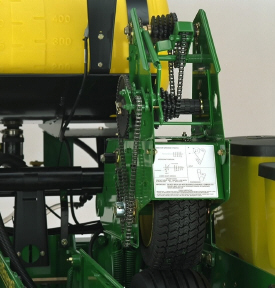 1765NT tire contact drive system
1765NT tire contact drive system
The tire contact drive for mechanical seed transmissions is a great fit for the mid-to-large planter operator concerned with quick transport capabilities, lower maintenance, and positive seed meter drives. The tire contact drive system is a simple, reliable, and efficient way to power seed transmission and meters.
The tire contact system drives the seed transmission mounted above the inner planter ground drive tire. A turf tire engages the ground drive tire when the planter is lowered, automatically turning the seed transmission and seed meters. Automatic drive disconnect occurs when the planter is raised and the turf tire separates from the ground-engaging tire. The system eliminates clutches, countershafts, and manual transport disconnects needed on direct ground drive systems. Drive chains and sprockets are moved up and out of the soil and residue zone for excellent reliability.
Tire contact drive systems are base equipment on the 1765, 1765NT, 1775 12-Row, and 1785 Planters. Contact between the ground-engaging tire and seed transmission tire is positive. On all models mentioned, a spring set applies downforce of the turf tire assembly onto the ground-engaging tire. System slippage is also minimized because the planter drive tires track in the tractor tire tracks. Frame designs differ (such as tire width) and the following different downforce requirements exist:
-
1765 8-Row drives have 207.3 kg (457 lb) of downforce.
-
1765 and 1775 12-Row drives have 254 kg (560 lb) of downforce.
The 1765 model uses one rear-mounted seed transmission. However, if the planter also has the fertilizer option, there is another rear-mounted transmission for the fertilizer drive. The 1785 Rigid Planters utilize one front-mounted seed transmission and if the planter is equipped with the liquid fertilizer option, another front-mounted transmission is utilized. The 1775 12-Row Planter utilizes two rear-mounted seed transmissions. Another rear-mounted transmission is used if the planter has the fertilizer option.
Features
MaxEmerge™ 5 row-unit
 MaxEmerge 5 with 56-L (1.6-bu) hopper plus insecticide
MaxEmerge 5 with 56-L (1.6-bu) hopper plus insecticide
 MaxEmerge 5 with mini-hopper on Central Commodity System (CCS™) machines only
MaxEmerge 5 with mini-hopper on Central Commodity System (CCS™) machines only
The MaxEmerge family of row-units have never seen a more versatile and efficient design until the MaxEmerge 5. The 5-family row-units improve productivity, increase uptime and lower the cost of ownership like never before.
The MaxEmerge 5 row-unit was designed for improved performance and serviceability.


Serviceability and changing crops has always been a focus of downtime and potential seed loss. MaxEmerge XP row-units (shown on the left) are designed with the meter and hopper as one component. The frame covers the meter so that it cannot be accessed. Cleanout of excess seed requires the operator to take the entire hopper off of the row-unit and to turn it upside down. The MaxEmerge 5 meter (shown on the right) is accessible without having to remove the box. The MaxEmerge 5 design allows large hoppers to be cleaned out the same as mini-hoppers, simply by opening the meter dome and catching the seed as it falls out. This improvement allows operators to change seed varieties easier and three times faster than it took them on the previous MaxEmerge XP units and provides more uptime during the tight planting window.
 MaxEmerge 5 vacuum seed meter
MaxEmerge 5 vacuum seed meter
The vacuum meter system gently pulls and holds individual seeds to the holes of the seed disk for population control and spacing accuracy, equaling better crop stands and profit. Vacuum seed meters can plant a wide variety of crops and seed types by simply changing seed disks and adjusting vacuum level. Vacuum seed meters are available for planters with MaxEmerge 5 row-units.
Additional features of the vacuum seed meter include:
- One moving component (the seed metering disk) for minimum maintenance requirements
- Meter located at each row-unit for accurate seed delivery
- Good hopper seed flow characteristics for longer operating time per hopper fill
- Low airflow in meter so seed treatments are not removed
 Pro-Series™ row-unit seed pool
Pro-Series™ row-unit seed pool
 MaxEmerge 5 seed pool
MaxEmerge 5 seed pool
The MaxEmerge 5 meter shape has also been redesigned for better seed flow. The mini-hopper design allows the planter to successfully operate on side hills up to 14 degrees.
Vacuum meter hub and latching handle
 MaxEmerge 5 vacuum meter with disk
MaxEmerge 5 vacuum meter with disk
Both the MaxEmerge 5 vacuum meters are equipped with a heavy-duty hub spring and disk latching handle. The spring ensures the seed disk stays properly positioned when operating flat-style seed disks and higher vacuum levels. Proper seed disk positioning means repeatable seed singulation, time after time. The disk-latching handle is designed for easy operation and effortless seed disk changeover. The hub is also machined to tight tolerances to further ensure alignment of metering components.
 Flat-style and cell seed disks shown
Flat-style and cell seed disks shown
The unique cell disk design allows planting a variety of seed sizes without any additional parts or individual meter adjustments. Another advantage of cell-type seed disks is the lower vacuum requirement compared to flat-style seed disks. Lower vacuum levels mean less hydraulic demand from the tractor. Most planting conditions call for a flat disk, if you are limited in hydraulic capacity, cell disks are recommended.
Operating characteristics of vacuum seed meter
 Operating speed with seed tube technology
Operating speed with seed tube technology
The vacuum seed meter is capable of operating at faster planting speeds than mechanical meters. However, planting accuracy will be influenced by seedbed conditions and the operating characteristics of the seed meter. Rough seedbeds and fast planting speeds (above 8.9 km/h [5.5 mph]) typically deteriorate seed placement accuracies when using seed tube technology.
The chart illustrates the effect operating speed has on population when using the vacuum meter. The operating band (color area) illustrates how the vacuum meter performs in relation to the desired population (indicated by horizontal line). The width of the band is due to various sizes and shapes of seeds and planting rate variations.
When operating on slopes above 15 degrees, increased or decreased population may result. To minimize this effect, reduce speed and consider using a flat style seed disk with increased vacuum level.
Vacuum meter seed disks
The ProMax 40 Flat Disk is a flat-disk planting solution field-proven to work since 1991.

The design of the ProMax 40 Flat Disk position allows seed to be released from the optimum position above the seed tube. The flush-face seed tube allows the seed to drop uninterrupted through the tube.
The ProMax 40 Flat Disk utilizes flat holes and a higher vacuum level to ensure every hole is populated with a seed. A double eliminator gently removes multiple seeds at each hole for precise population control. A knockout wheel makes certain that each hole is clear of any debris after the seed is released from the disk.
Double eliminator

For difficult to singulate seeds, a flat seed disk and double eliminator is a viable alternative to traditional cell-type seed disks. By design, a flat seed disk requires higher levels of vacuum than a cell-type disk because there is no pocket or cell to hold the seed. The higher vacuum level will pull more than one seed to the holes in the seed disk. The double eliminator is set to cover a portion of the hole in the seed disk and is the mechanism to knock multiple seeds away as the disk rotates.
Double eliminators are required with flat-type seed disks only and should not be used with cell-type seed disks. The knockout wheel is also recommended in conjunction with the double eliminator and flat seed disk to ensure seed is ejected from the disk.
Flat and celled type seed metering disks are available to allow planting a wide variety of seed types.
- Corn (field, popcorn, or sweet corn)
- Soybeans
- Cotton
- Sorghum
- Sugar beets
- Sunflowers
- Edible beans/peas
- Peanuts
- Melons, squash, cucumbers
Mini-hopper row-units, which are used only with the CCS, are compatible only with crops that the CCS is approved to plant.
- Corn
- Popcorn
- Sweet corn
- Soybeans
- Sunflowers
- Sorghum
- Cotton
NOTE: Due to small seed size and low planting populations, sugar beets can be planted with mini-hopper style meters by adding hopper extensions and not using the CCS tank. These hopper extensions can also be used for planting test plots.
 Hopper shutoff
Hopper shutoff

Also, to help with meter access of 56-L and 106-L (1.6-bu and 3-bu) hoppers the hopper shutoff feature was added. With the shutoff engaged, the meter cover can be opened without first having to remove all of the seeds from the hopper. Lever down, the seed flow is on, lever horizontal and the seed flow is off.
 MaxEmerge 5 mini-hopper
MaxEmerge 5 mini-hopper

There are significant changes to the MaxEmerge 5 mini-hopper. One update is the straight feed from the CCS hose to the mini-hopper to ensure a continuous free flow of seeds. This design change reduces the potential for plugging issues with larger seed size and the use of seed treatments. By drawing air from the CCS tank, the vacuum source is cleaner, preventing meter debris buildup.
 Ductile iron-cast shank
Ductile iron-cast shank

Ductile iron casting is a unique high-tech process that produces a single-piece row-unit shank this enables alignment from the seed trench to the closing wheel.
The row-unit head is also designed using the ductile iron-casting process. The row-unit head provides the mating joints between the row-unit parallel arms and the row-unit shank. It is also the upper attaching point for the seed meter and seed hopper.
Ductile iron casting of the row-unit shank and head assembly provides a row-unit that is 25 percent stronger than other competitive welded row-units.

One of the trademark capabilities of John Deere planters has always been the ability of the Tru-Vee openers to provide an ideal seed furrow.
The thickness of the Tru-Vee opener blade is 3.5 mm (0.14 in.) this blade thickness will provide extended wear life.
The MaxEmerge 5 row-unit also provides better Tru-Vee opener bearings for longer life. The double-row ball bearing provides up to three times the wear life as the single-row bearing.
 Depth adjustment T-handle
Depth adjustment T-handle

John Deere planters provide consistent seed depth control in all field conditions. Depth control is a function of the Tru-Vee openers, the downforce system, and the gauge wheel assembly.
The gauge wheel itself is made of durable nylon composition with a concave profile. This profile gently firms the sides of the seed furrow, ensuring a well-defined trench. The shape reduces rocks and residue being picked up and thrown onto the drive chains and row-units, and helps to prevent rooster tailing of soil.
The bolt-through design utilizes an open bearing in the gauge wheel that allows an attaching bolt to pass through the wheel to the threaded hole in the gauge wheel arm. This simple bolt-through design provides for a positive attachment of the gauge wheel to the gauge wheel arm and allows quick removal of the gauge wheel for service.
Adjustability of the row-unit is critical to good performance. More available downforce options than any row unit in the industry
- Adjustable heavy-duty downforce, four settings, 0 kg (0 lb), 57 kg (125 lb), 113 kg (250 lb), and 181 kg (400 lb) of downforce
- Pneumatic downforce, infinitely variable from 0 to 181 kg (0 to 400 lb) of downforce
- Active pneumatic downforce adjusts automatically for changing ground conditions from 0 to 181 kg (0 to 400 lb) of downforce
 Rubber tire closing system
Rubber tire closing system
 Cast wheel closing system
Cast wheel closing system
Rubber tire closing systems are used for most conventional, minimum-till, and no-till planting conditions. The spacing between the wheels is adjustable so the closing system can meet the needs of those who want to plant small seeds at shallow depths.
The wheels can also be staggered fore and aft to enhance residue flow. Four levels of spring force are available and are easily set with the integrated T-handle adjustment. A lower force spring can be obtained from parts, if a lower amount of force is required.
Additional closing wheel options include:
- Cast closing wheels, for tough-to-close conditions
- Disk closing, for shallow planting depths
- Closing wheel frame less wheels, for growers desiring to use aftermarket closing wheels
1765 and 1765NT Drawn Rigid and flexible wing-fold frame
Designed with conventional, mulch-till, and no-till planting conditions in mind
 1765NT Drawn Wing-Fold Planter
1765NT Drawn Wing-Fold Planter
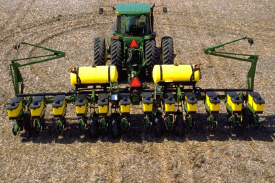 1765 12Row30 Drawn Wing-Fold Planter
1765 12Row30 Drawn Wing-Fold Planter
Both the 1765 and 1765NT (narrow transport) feature a rugged 177.8-mm x 177.8-mm (7-in. x 7-in.) frame, wheel module lift system, and tire contact drive system. The 12Row30 flexible-frame model feature a two-section, center flexing frame design that flex 20 degrees up and 20 degrees down. The 1765 and 1765NT are recommended for conventional, mulch-till, and most no-till planting conditions.
The 1765 Planter family is available in the following frame configurations including both rigid and flex options:
- 8Row30 Narrow Transport (NT) rigid frame
- 12Row30 rigid frame
- 12Row30 flex frame
Frame functionality
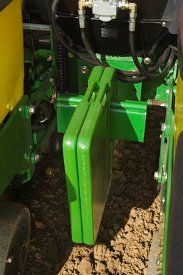 1765 Flex center frame weight bracket
1765 Flex center frame weight bracket
For 1765 and 1765NT Wing-Fold Planters that are operating less fertilizer or would require more frame weight for tough soil conditions, additional weight can be added to the center frame. A mounting bracket and six weights add approximately 272.2 kg (600 lb) to the planter. This weight prevents the frame from flexing up in the center when planting.
Use AA41141 ballast bracket and six tractor front end weights. Attach the bracket with seven 19M7597 (M20x50) bolts and 14M7277 nuts.
Tractor attaching options
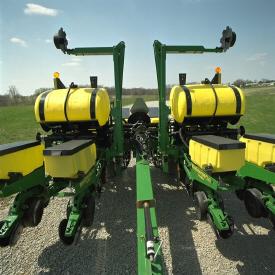 1765 and 1765NT Planters offer one hitch length
1765 and 1765NT Planters offer one hitch length
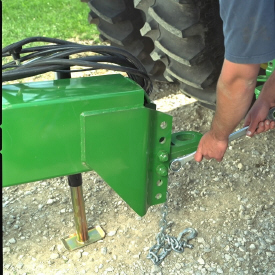 Adjustable hitch settings to match tractor height
Adjustable hitch settings to match tractor height
The 1765 and 1765NT Wing-Fold Planters have one hitch length available: 373.4 cm (147 in.) for planters used with a dual-wheel-equipped tractor. The long 373.8-cm (147-in.) hitch options are available for all frame widths and can be equipped with either a clevis (code 2820) or ring (code 2810) style hitch link. Order the style of hitch link desired.
Hitches are adjustable, providing three hitch settings to match tractor drawbar height, resulting in level planter operation.
Transportability
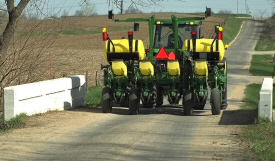 1765NT Planter transports at 3.7 m (12 ft)
1765NT Planter transports at 3.7 m (12 ft)
Narrow Transport (NT) planters provide a compact transport width of only 3.7 m (12 ft).
Wing folding of all 1765 Planters is hydraulically-controlled. The independent marker option and hydraulic-fold option are plumbed together using a diverter valve (code 868A) when both options are ordered (reduces selective control valve [SCV] requirements by one).
Model |
Transport width with markers |
Transport height* |
8Row30 NT |
3.7 m (12 ft) | 3.3 m (10.75 ft) |
12Row30 |
4.8 m (15 ft, 8 in.) | 3.05 m (10 ft) |
| *Height measured with 18.4R-46 rear tires on tractor | ||
Fertilizer capabilities
Both the 1765 and 1765NT Planters can be equipped with a liquid fertilizer system. Eight-row configurations carry two fertilizer tanks totaling 1135.6 L (300 gal.) of capacity. The 1760 12Row30 model can handle 1703.4 L (450 gal.) of fertilizer in two tanks.
The use of the single-disk, unit-mounted injection fertilizer opener or the frame-mounted, single-disk fertilizer opener makes the 1765 and 1765NT no-till capable. The 1765 equipped with the unit-mounted, double-disk fertilizer opener is not well suited for no-till applications and opener penetration may be limited by soil conditions. Frame-mounted, single-disk fertilizer opener is only compatible with 1765NT Planters.
SeedStar™ 2 monitoring system
Integrated innovation is what operators will appreciate with the SeedStar 2 monitoring system and GreenStar™ 2 Display. An increasing number of acres combined with rising seed costs drive the need to easily understand planter functions and monitor performance. It is all about making every seed count and that is what SeedStar 2 delivers.
The SeedStar 2 monitoring system is a full-feature, color, seed population monitor used in conjunction with the GreenStar family of displays. SeedStar 2 is compatible with the GreenStar 2 1800 and 2600 Displays, GreenStar 3 2630 Display, the Gen 4 4200 CommandCenter™ Display, the Gen 4 4600 CommandCenter Display, the 4240 Universal Display, and the 4640 Universal Display. SeedStar 2 is not compatible with the Gen 4 Extended Monitor. Conveniently, SeedStar 2 planting functions are fully integrated with the full spectrum of Precision Ag Technology applications—guidance, coverage maps, and field documentation can be shown all on one display.
When a SeedStar 2 system is used on a planter, there is no need for a ComputerTrak™ monitor. All vital planting information is displayed in one central, easy-to-read location.
SeedStar 2 features
 SeedStar 2 full-screen planter run page
SeedStar 2 full-screen planter run page
SeedStar 2 is a user-friendly system that has retained all the valued features of SeedStar and incorporated the next generation of enhancements. For example, on-screen color indicators show drive engagement/disengagement status. In addition, three color planter-at-a-glance bars (black, orange, or red) visually inform the operator of row population status.
Not only does SeedStar 2 incorporate the use of color, it also utilizes an intuitive icon and folder based operator interface. Icons are easy to understand across many languages and reduce the need for text. Icons for planter main run page, planter setup, seed/crop setup, totals, and diagnostics are located in the soft-key region of the display. Setup is performed by selecting the appropriate icon and then choosing the tabs to enter/select information.
The SeedStar 2 monitor offers all of the features and functionality of the ComputerTrak 350 monitor and much more. SeedStar 2 monitors the following planter functions:
- Row population/spacing
- Row failure
- Average population (entire planter and by variable-rate drive [VRD] motor section)
- Vacuum level
- Fertilizer pressure
- Acre counter
- Total acreage
- Tractor speed
In addition, planter operational information is available within the SeedStar 2 monitor system. Such operational information includes population charts, seed disk vacuum settings, and setting recommendations for the piston pump liquid fertilizer system.
All SeedStar 2 systems have the capability, through a single controller, to perform both the seed monitoring and variable rate drive functions. SeedStar 2 monitoring is required for VRD population control. Even though the planter may not be equipped with SeedStar 2 VRD, the SeedStar 2 monitoring system is available and will allow for future installation of VRD.
SeedStar 2 enhancements
 SeedStar 2 half-screen planter run page
SeedStar 2 half-screen planter run page
 SeedStar 2 showing half-width disconnect status
SeedStar 2 showing half-width disconnect status
The SeedStar 2 enhanced planter features include:
- GreenStar 2 display integration – eliminates the need to operate the GreenStar 2 2600 Display in the original GreenStar monitor mode or the use of dual displays.
- User-friendly, intuitive icons
- Half- or full-screen run page
- On-screen, color drive status – a quick glance at the display tells the operator if the half-width disconnect is engaged or disengaged.
- Three-color planter-at-a-glance population bar – a black bar indicates that population is close to target and within established limits; orange shows the population is above/below the alarm set point; and red signals the population is out of operating range or is not planting.
- Three-piece, color VRD indicator – each piece of the VRD gear pie turns green when the wheel motion sensor is active, planter is lowered, and drives are engaged.
SeedStar monitoring original features
SeedStar 2 retains all those SeedStar features that producers value and have come to expect:
-
Planter at a glance – allows operator to view relative population levels of all rows on one screen.
-
Automatic valve calibration – with the SeedStar VRD, this is now completed automatically. There is no longer a need to manually calibrate the hydraulic valves.
-
Increased population updates – SeedStar will now update population levels once a second at planter start up then approximately once every three seconds.
-
Mapping of actual seed rates – When combined with Field Doc™ system, actual and target seeding rates can now be mapped in APEX™ software.
-
Reprogrammable utilizing controller area network (CAN) via Service ADVISOR™ diagnostics system.
-
Improved diagnostics/event recorder – on SeedStar VRD planters, additional diagnostic information is available, as well as an event recorder to capture system performance data at a specific point in time.
-
Ability to run motors at different population levels – on SeedStar VRD, operators running multiple motor systems can run each motor at a different speed, allowing different population levels within a planter.
-
User-configurable high fertilizer pressure alarm – allows the operator to be warned when fertilizer pressure reaches a specific level.
-
Automatic quick-start for SeedStar VRD – the operator no longer needs to press the quick-start button on end row turns to resume planting.
-
Automatic tractor speed source selection – when equipped with an 8000/9000 Series Tractor, the system selects the radar speed or allows for manual speed input selection.
Downforce system options

Heavy-duty adjustable downforce springs
 Heavy-duty adjustable downforce spring
Heavy-duty adjustable downforce spring
Planter row-unit downforce is an important factor to ensure consistent and proper depth control. The heavy-duty adjustable downforce feature provides up to 181.4 kg (400 lb) of downforce. There are four settings available to allow the operator to choose the amount of downforce required for the condition: 0 kg (0 lb), 56.7 kg (125 lb), 113.4 kg (250 lb), and 181.4 kg (400 lb).
Compatibility: 1705, 1715, 1725, 1735, 1755, 1765, 1765NT, 1775 Flex, and 1785
Standard pneumatic downforce system
Pneumatic downforce provides convenient, simple adjustment of downforce for the whole planter from one location. The amount of downforce applied is infinitely adjustable from 0 to 181.4 kg (0 to 400 lb). Pneumatic downforce provides more consistent downforce throughout the range of row-unit travel than mechanical spring downforce systems.
Features include:
- 9.5-mm (3/8-in.) air delivery line instead of the 6.4-mm (1/4-in.) line used on model year 2010 and older planters.
- Air compressor assembly increased duty cycle. With this compressor, it provides a 47 percent increase in maximum air flow delivery compared to the prior air compressor.
- Pneumatic air bags with 9.5-mm (3/8-in.) air line inlets that have greater durability.
 Pneumatic downforce spring
Pneumatic downforce spring
Each row-unit has a single rubber air bag located between the parallel arms. The air bags are hooked in parallel so that air can be added or released from all rows at once from one location.
The individual pneumatic downforce air bag assemblies, air compressor units, and 9.5-mm (3/8-in.) delivery lines are also available as an attachment for field conversion.
 Pneumatic downforce compressor and gauge
Pneumatic downforce compressor and gauge
An improved compressor is used to charge the pneumatic system. This compressor can be located on the planter frame or in the tractor cab if desired. A gauge at the compressor indicates the amount of downforce being applied.
From the factory, integral planter models with pneumatic downforce will have an improved air compressor assembly with an in-cab mounting bracket, except for the 1725 16-row and 1725 Central Commodity System (CCS™) twin-row planters, which will have the air compressor assembly mounted on the planter frame. For drawn planter models, the 1755, 1765, 1765NT, 1775 Front-Fold, and 1785 Drawn Planters will have the air compressor assembly installed either on the outer hitch or wing frame members when the pneumatic downforce system is installed.
Base equipment on: 1705, 1715, 1725, 1735, 1755, 1765, 1765NT, 1775 and 1785.
Integrated pneumatic downforce system
The functional features of the integrated system are the same as the standard pneumatic system, explained above, with the addition of control through the GreenStar™ display.
SeedStar XP row-unit downforce planter run page
 SeedStar XP downforce planter run page
SeedStar XP downforce planter run page
Active downforce control is integrated into SeedStar XP and SeedStar 3 HP monitoring systems.
Margin is the amount of weight riding on the depth gauge wheels that ensures desired firming of the seedbed as set by the operator.
Once a target margin has been defined, enter the value into SeedStar XP or SeedStar 3 HP and let active downforce do the rest. The system will actively adjust the air pressure in the air bags to maintain a constant margin across the planter. The changes in air pressure will change the amount of downforce placed on the row-unit, compensating and reacting for varying conditions through the field whether it is different tillage practices, soil types, or moisture.
System control with the GreenStar display
 Pneumatic downforce control in GreenStar 2 Display
Pneumatic downforce control in GreenStar 2 Display
 Air compressor mounted on 1775NT outer hitch
Air compressor mounted on 1775NT outer hitch
On 1725 16-row, 1725 CCS TR, 1775NT, 1775NT CCS, 1795, DR, and DB Series Planter models, the air compressor will be mounted on the outer hitch or frame assembly. Since the air compressor assembly is mounted on the outer hitch (as noted in the picture above) or frame, adjustments for row-unit downforce and related system pressures will be made electronically with the GreenStar display.
When adjusting the amount of row-unit downforce using the GreenStar display, the operator will select the amount of downforce (kg [lb]) to be applied across the planter. Depending on the soil conditions at hand, the operator might need to adjust the relative amount of row-unit downforce being applied during the planting operation. The integrated pneumatic downforce controls within the GreenStar display will only allow for set-point operation and not automatic control as the planter is operating in different soil conditions. The pneumatic downforce system does not have the capability to automatically adjust downforce.
On-board air storage
 Onboard air storage installed on 1775NT 24R30
Onboard air storage installed on 1775NT 24R30
The 1725 16-row, 1725 CCS TR, 1775NT, 1775NT CCS, 1795, DR, and DB Series planters will have onboard air storage to increase the overall response time when making a row-unit downforce adjustment from the GreenStar display. The onboard air storage is comprised of a 18.9-L (5-gal.) storage tank with valve assembly.
Base equipment on: 1725 CCS, 1725 16-row, 1725T, 1775NT, 1775NT CCS, 1795, DR, and DB Series Planters with MaxEmerge™ 5 row-units. MaxEmerge 5e and ExactEmerge™ equipped planters come with active pneumatic downforce in base.
Active pneumatic downforce
 Active downforce compressor assembly
Active downforce compressor assembly
 Hydraulic motor
Hydraulic motor
A hydraulically driven compressor works with the SeedStar™ 3 HP system and SeedStar XP system to automate downforce control. Just set the row-unit target margin value and the active pneumatic downforce system works automatically. The system will make sure the planter maintains this value, achieving precise soil penetration, and consistent planting depth, without sidewall soil compaction. From the factory, the system is set at 45.4 kg (100 lb) target downforce margin, but may be modified for varying field conditions. This frees the operator from constantly making manual downforce adjustments as conditions change.
This system offers a split-rank control feature for 1795 and DB Split-Row Planters. On split-row planters, active downforce will control the front and rear rows independently. This compensates for differing downforce requirements between the ranks that can be caused by things like different tillage or insecticide attachments and will help maintain an accurate planting depth and consistent margin across all the rows.
Active pneumatic downforce is available as factory installed or as an attachment for field conversion.
 IRHD screen showing the ground contact graph
IRHD screen showing the ground contact graph
 IRHD screen showing the applied downforce graph
IRHD screen showing the applied downforce graph
Optional equipment on: 1775NT, 1795, DB, and Orthman custom models with MaxEmerge 5e and ExactEmerge row-units.
 Downforce and margin example
Downforce and margin example
- A - Margin – amount of additional downforce applied to a row-unit above and beyond what is required for penetration to achieve planting depth. This additional weight will ride on the depth gauge wheels. 54.4 kg (120 lb) + 36.3 kg (80 lb) = 90.7 kg (200 lb) – 68 kg (150 lb) = 22.7 kg (50 lb) of margin
- B - Weight of row-unit - 54.4 kg (120 lb)
- C - Downforce – force that is applied to the row-unit by the air bag circuit - 36.3 kg (80 lb)
- D - Resistance from soil - 68 kg (150 lb)
Hydraulically driven compressor
 Hydraulic motor
Hydraulic motor
 Pneumatic valve
Pneumatic valve
The hydraulically driven air compressor can deliver up to eight times the air flow, allowing for more and faster downforce changes to be made. This more robust design features a 37.8-L (10-gal.) storage tank across all models with active downforce.
At approximately 15.1 L/min (4 gpm), hydraulic demands are low and ties into the machine’s lift and CCS hydraulic circuit so it does not require any additional selective control valves (SCVs). The SeedStar XP and SeedStar 3 HP monitoring systems work with the compressor and valve assembly to regulate air to downforce springs, enabling the active control.
Another feature of John Deere active downforce is the ability for the pneumatic valve to independently control split-rank machines. This system senses the downforce needs from the front and rear ranks separately and independently adjusts air pressures with the dual-rank pneumatic valve when equipped. Active pneumatic downforce requires SeedStar XP or SeedStar 3 HP to enable active control.
Base equipment on: All MaxEmerge 5e and ExactEmerge equipped planter models.
Individual Row Hydraulic Downforce (IRHD)

IRHD has been specifically designed to meet the needs of producers that are looking to adjust to the toughest field conditions and provide maximum yield potential from field to field, season after season. IRHD works as a closed-loop downforce system that reacts quickly on an individual row basis to changing soil conditions supporting increased ground contact, which can lead to improved seed depth consistency. When setting planter downforce margin, the system will apply the needed downforce by row to maintain ground contact. From the factory, the margin will be set at 45.4 kg (100 lb), changes may be required based on varying field conditions.
The system allows operators to maintain gauge wheel ground contact leading to desired seed depth placement. IRHD can adjust five times per second and make adjustments of 45.4 kg (100 lb) in less than a second. The system has a total range of applied downforce from 22.7 kg (50 lb) to 204.1 kg (450 lb) and utilizes the power beyond circuit on the tractor. IRHD is 58 percent faster than the active pneumatic downforce solution. Fast reaction and increased ground contact can lead to improved emergence. With uniform emergence, some studies have shown a yield impact from 5 percent to 9 percent.
IRHD is controlled through the Gen 4 4600 CommandCenter™ Display or 4640 Universal Display with SeedStar 4HP. As shown below, operators can view ground contact or applied downforce using the toggle button.
RowCommand™ individual-row control system
RowCommand controls seed output
 RowCommand on a MaxEmerge™ 5 row-unit
RowCommand on a MaxEmerge™ 5 row-unit
 RowCommand on a chain drive MaxEmerge 5 row-unit
RowCommand on a chain drive MaxEmerge 5 row-unit
Controlling input costs and improving productivity are key producer requirements today. RowCommand is an effective, integrated John Deere solution designed to meet these intensifying needs. The RowCommand system manages seed output, reduces yield drag, and improves harvest capabilities on all Pro-Shaft™ driven row-units, and chain-driven MaxEmerge 5.
NOTE: Chain-drive RowCommand is only compatible with planters equipped with pneumatic downforce systems. On planters equipped with the heavy-duty downforce springs, potential chain interference may result and is not recommended.
NOTE: Chain-drive RowCommand requires some modification to brackets in order to function with corn finger pickup meters.
NOTE: Pro-Shaft drive RowCommand is compatible on MaxEmerge 5 row-units with vacuum and corn finger pickup meters. For mini-hopper row-units, RowCommand is compatible on vacuum meters only and is not compatible on corn finger pickup meters. Pro-Series™ XP row-units with corn finger pickup meters are not compatible with RowCommand.
RowCommand controls seed output by incorporating individual, low amperage clutches inside the Pro-Shaft and chain-driven gearboxes. Clutches are completely enclosed within the gearbox housing to protect them from the elements and harsh operating conditions.
When power is supplied, either manually or through John Deere Section Control software, clutches disengage the seed meters and seed flow stops. Controlling seed output at individual rows reduces overplanting in point rows and maximizes seed placement when entering/exiting headlands.
Components and operation
 Electronic power modules shown on a 1775NT Planter
Electronic power modules shown on a 1775NT Planter
 RowCommand clutch on MaxEmerge 5 with 105.7-L (3-bu) hopper
RowCommand clutch on MaxEmerge 5 with 105.7-L (3-bu) hopper
RowCommand is a simple and efficient solution to control individual row planting. This system does not utilize air to operate; therefore, no compressor, air lines, or valve modules are required.
RowCommand utilizes low-voltage controller area network (CAN) messaging to signal power to the desired clutches to stop planting or eliminates power to resume planting.
This means very little power is used in normal planting conditions, and in the event a clutch fails electrically, the meter will continue to plant.
The RowCommand system requires the following five basic components to operate:
-
Electric clutches
-
Electronic power modules (EPMs)
-
SeedStar™ 2 monitoring (wedge box/controller)
-
GreenStar™ (GS) display
-
Planter wiring harnesses
Clutches are protected within the sealed Pro-Shaft and chain-driven gearboxes for years of trouble-free operation and simple installation or removal. RowCommand has true individual-row control of up to 16 clutches or sections for planters larger than 16 rows.
Unique to RowCommand, the 16 available control sections can be configured based on operator preferences. For example, on a 1775NT 24-Row Planter, every two rows can be paired together for a total of 12 control sections, or control the outermost eight rows individually and the remaining inner rows paired together for 16 control sections.
While SeedStar with RowCommand has 16 control sections, a minimum of 152.4-cm (60-in.) wide sections are recommended for optimum Swath Control Pro™ solution capabilities. As with other Swath Control Pro products, an SF2 signal is the minimum level of accuracy recommend for operation.
Integrated Swath Control Pro
Coupling RowCommand with Swath Control Pro provides the ultimate in precision planting and productivity. One company, one integrated solution are what we offer by incorporating Swath Control Pro capabilities within the SeedStar 2 wedge box (controller). Unlike previous systems, no rate controller, additional harnessing, or components are required to achieve automated individual-row control.
SeedStar 2 monitoring, RowCommand, and Swath Control Pro activation from John Deere Precision Ag Technologies are all that is needed when ordering.
Pro-Shaft drive RowCommand planters
RowCommand is available as a factory-installed option or as an attachment for field conversion attachments for the following Pro-Shaft drive planter models (see chart below).
| Planter model | Row configuration |
| 1725 | 12-row narrow, 12-row wide, and 16-row narrow |
| 1725 Central Commodity System (CCS™) | 16-row narrow |
| 1765 | 12-row narrow |
| 1775 | 12-row narrow |
| 1775NT | 12 row, 16 row, and 24-row narrow |
| 1775NT CCS | 12 row, 16 row, and 24-row narrow |
| 1795 | 12/23 row, 12/24 row, 16/31 row, and 16/32 row |
| 1795 | 24 row, 50.8 cm (20 in.) |
| DB 44 | 24 row, 55.9 cm (22 in.) |
| DB 58 | 32 row, 55.9 cm (22 in.) |
| DB 60 | 36 row, 50.8 cm (20 in.) or 47 row, 38.1 cm (15 in.) |
| DB 66 | 36 row, 55.9 cm (22 in.) |
| DB 80 | 32 row, 76.2 cm (30 in.) or 48 row, 50.8 cm (20 in.) |
| DB 88 | 48 row, 55.9 cm (22 in.) |
| DB 90 | 36 row, 76.2 cm (30 in.) |
| DB 120 | 48 row, 76.2 cm (30 in.) |
| DR (Deere/Orthman™ planter) 16R40 | 16 row, 101.6 cm (40 in.) |
| DR (Deere/Orthman) 18R38 | 18 row, 96.5 cm (38 in.) |
Chain-drive RowCommand planters
In terms of planter compatibility, RowCommand for chain drive is designed for the following planter model configurations equipped with pneumatic downforce systems.
| Planter model | Row configuration |
| 1725 | 12-row narrow, 12-row wide, and 16-row narrow |
| 1765 | 12-row narrow |
| 1775 | 12-row narrow |
| 1775NT | 12 row and 16 row |
| 1775NT CCS | 12 row and 16 row |
| DB 44 | 24 row, 55.9 cm (22 in.) |
Chain-drive RowCommand and heavy-duty downforce
 Chain interference with heavy-duty downforce
Chain interference with heavy-duty downforce
As seen in the image, chain interference may result when operating chain-drive RowCommand on planters equipped with short and long parallel arms and heavy-duty downforce springs.
NOTE: Chain-drive RowCommand is only compatible with planters equipped with pneumatic downforce systems. On planters equipped with the heavy-duty downforce springs, potential chain interference may result and is not recommended.
Chain-drive RowCommand with corn finger pickup meters
 Bracket material removal
Bracket material removal
Due to the design characteristics of the chain-drive RowCommand clutch, some modification to the corn finger pickup meter drive bracket is required. As seen in the picture to the left, some material needs to be removed from the front of the meter drive bracket in order for the chain-drive RowCommand clutch to have sufficient space for installation.
NOTE: Chain-drive RowCommand requires some modification to brackets in order to function with corn finger pickup meters.
RowCommand ordering information
To add RowCommand to a model year 2009 and newer planter model listed above is simple. Pro-Shaft drive attachments for field conversion and chain-drive attachments for field conversion are available by planter model to add the appropriate number of clutches, EPMs, brackets, hardware and row-unit harnesses. For complete installation and part detail for the RowCommand conversion, please use the RowCommand compatibility tool per specific planter model.
RowCommand is compatible and available for model year 2003 (serial number 700101) to 2008 (725101) planter models listed above. In addition to the attachment for field conversion attachment, a planter mainframe harness, SeedStar 2 controller (wedge box), and additional CAN harnesses are needed.
System requirements
RowCommand is a simple and efficient means to control individual row planting through the use of low-voltage electric clutches. When activated, each clutch consumes no more than 0.5 amps. By design, power is only supplied to the clutch when a signal is received to stop planting. In a normal planting condition, no power is supplied and the clutch is de-energized.
Power for the RowCommand system is provided from the 9-pin ISO implement connector. All late-model 8X00 and 9X00 Series John Deere Tractors equipped with the 9-pin ISO implement connector are capable of supplying ample power for system operation.
Along with ample system power, a GreenStar display and SeedStar monitoring are required for operation and control interface. The GreenStar display is where system setup, control settings, and manual control functions are performed.
Seed variable-rate drive
Seed variable-rate drive provides the ultimate planting productivity by utilizing one, two, or three hydraulic motors (varies by model) to turn the seeding drive shaft. Hydraulic control of the seeding drive allows for on-the-go seeding rate changes right from the display mounted inside the tractor cab. Combine this seeding flexibility with the map-based planting option, and seeding rates adjust automatically based on the prescribed map.
Variable-rate drive offers the following advantages over common, ground, or contact-tire drive systems:
-
Rate changes are almost instantaneous; no ramp up or ramp down of system as in some competitive systems
- Permits the producer to match seed population based on different soil types or irrigation practices
- John Deere design provides added operator safety by eliminating any possible drive creep found in some competitive variable-rate drive systems
 1755 equipped with variable-rate drive
1755 equipped with variable-rate drive
 1765NT equipped with variable-rate drive
1765NT equipped with variable-rate drive
Single- or dual-motor systems for variable-rate drives are available for all John Deere planters except the 1785 Rigid Frame. Variable-rate drive is available as a factory-installed option for all applicable planter models.
Single- or dual-motor systems are available as field-installed attachments for most planter models; however, a three-motor variable-rate drive field-installed attachment is not available.
Seed variable-rate drive requires the SeedStar™ monitor and a radar input signal. Either tractor or planter radar may be used. Planter radar is ordered separately.
NOTE: Peanut seed meter disks require the variable-drive transmission.
Seed variable-rate drive (VRD) with half- or three-width disconnect
 VRD shown on a 1775NT
VRD shown on a 1775NT
The seed variable-rate drive provides the ultimate planting productivity by utilizing one, two or three hydraulic motors (varies by model) to turn the seeding drive shaft. Hydraulic control of the seeding drive allows for on-the-go seeding rate changes right from the display mounted inside the tractor cab.
Combine this seeding flexibility with the map-based planting option, and seeding rates adjust automatically based on a prescription map.
Single- or dual-motor systems for variable-rate drives are available for all John Deere planters except the 1785 Rigid Frame. Dual- or three-motor drive systems are commonly used on larger (12-row and more) planters and offer the capability of half-width or three-section drive disconnect.
The VRD is available as a factory-installed option for all applicable planter models. Single- or dual-motor systems are available as field-installed attachments for most planter models; however, a three-motor VRD field-installed attachment is not available.
The seed VRD requires the SeedStar™ monitor and a radar input signal. Either tractor or planter radar may be used. Planter radar is ordered separately.
VRD offers the following advantages over common, contact-tire drive systems:
-
Almost instantaneous rate changes – there is no ramp up or ramp down of system as in some competitive systems
- Permits the operator to match seed population based on different soil types or irrigation practices
- John Deere design that provides added operator safety by eliminating any possible drive creep found in some competitive variable rate drive systems
Half-width drive disconnect
The half-width drive disconnect feature is excellent for the producer concerned with controlling seed costs. This feature helps the operator place seed in the desired area and limit the amount of costly overlapped planting.
The half-width drive disconnect allows the operator to turn off half of the planter at a time for planting end rows, point rows, etc. Variable-rate-equipped planters require two drive motors to utilize the half-width disconnect feature.
 Half-width drive disconnect within frame control
Half-width drive disconnect within frame control
With a 1765, 1765NT, and 1775 12-Row Planter, a single switch box is required for planters that are ordered with variable rate drive and half-width disconnect.
For the 1775NT, 1775NT Central Commodity System (CCS™), and 1795 Front-Folding Planters, the half-width drive disconnect switch is contained within the frame control box, conveniently located in the tractor cab. The function easily shuts off the drive for the left or right half of the planter row-unit seed meters.
Three-width drive disconnect
 Three-width drive disconnect control
Three-width drive disconnect control
Three-width drive disconnect is an option on 1725 12-Row Planters and is base equipment on the 1725 16Row30 Planter. This feature is activated by three individual console mounted switches (control box), conveniently located in the tractor cab. The function easily shuts off the planter row-unit seed meters by one-, two-, or three-drive segments independently.
Row cleaner options to meet residue management needs
Crop yields have increased through the years along with the amount of residue left in the field after harvest. At the same time, tillage practices have changed, including different tillage operations which maintain large amounts of surface residue, and even no-till practices. Row cleaners are an essential tool in managing this increased amount of residue.
John Deere seeding group offers a variety of row cleaner options to meet the needs of a producer's operation. Compatibility varies by model, row spacing, and other planter equipment.
Screw-adjust, unit-mounted row cleaner
 Screw-adjust, unit-mounted row cleaner
Screw-adjust, unit-mounted row cleaner
The screw-adjust, unit-mounted row cleaner is mounted directly to the face plate of the row-unit, placing the ground engaging components just in front of the row-unit opener blades and depth gauge wheels. This close proximity allows the gauge wheels to control the depth of the row cleaner as well as the row-unit. This compact design also allows greater compatibility with fertilizer openers and other planter attachments.
SharkTooth® wheels are standard equipment on the unit-mounted row cleaner. The swept-tooth design of the wheel provides a clear path for the row-unit openers while resisting residue buildup on the wheel. The screw adjustment knob is accessible through the top of the parallel arms, providing convenient access for adjustments. The row cleaner can be adjusted in 1.6-mm (1/16-in.) increments, providing plenty of flexibility to meet the needs of changing conditions.
Floating row cleaner with unit-mounted coulter
 Floating row cleaner with unit-mounted coulter
Floating row cleaner with unit-mounted coulter
The floating row cleaner allows a row cleaner to be used in conjunction with a unit-mounted coulter. This combination is often desired in heavy residue loads and reduced tillage planting conditions. The row cleaner provides a clear path for the row-unit, while the unit-mounted coulter helps penetrate tough soil conditions.
Accommodating the unit-mounted coulter means the residue wheels are farther forward from the row-unit face plate than in the case of the screw-adjust row cleaner. To maintain performance, this row cleaner has the capability to float above a defined minimum depth.
Standard depth-gauging bands on the wheels allow the row cleaner wheels to float independently of the row-unit openers, allowing both to perform in varying terrain. The unit may also be set in a fixed position by simply pinning through the bracket if desired. This row cleaner also features SharkTooth wheels as standard equipment.
The floating row cleaner and unit-mounted coulters are available on many planters as factory-installed equipment. As compatibility and details vary by model, review the following links for information on specific planter models.
NOTE: Screw-adjust row cleaners are not compatible with MaxEmerge™ 5e row-units with long parallel arms.
NOTE: DB models have the option for either unit-mounted coulter, screw-adjust row cleaners, or pneumatic row cleaners (only compatabile with MaxEmerge 5e or equipped ExactEmerge™ models). The DB60T is only available with a less row cleaner option.
SharkTooth is a trademark of Yetter Manufacturing, Inc.
Tire contact drive system
 1765NT tire contact drive system
1765NT tire contact drive system
The tire contact drive for mechanical seed transmissions is a great fit for the mid-to-large planter operator concerned with quick transport capabilities, lower maintenance, and positive seed meter drives. The tire contact drive system is a simple, reliable, and efficient way to power seed transmission and meters.
The tire contact system drives the seed transmission mounted above the inner planter ground drive tire. A turf tire engages the ground drive tire when the planter is lowered, automatically turning the seed transmission and seed meters. Automatic drive disconnect occurs when the planter is raised and the turf tire separates from the ground-engaging tire. The system eliminates clutches, countershafts, and manual transport disconnects needed on direct ground drive systems. Drive chains and sprockets are moved up and out of the soil and residue zone for excellent reliability.
Tire contact drive systems are base equipment on the 1765, 1765NT, 1775 12-Row, and 1785 Planters. Contact between the ground-engaging tire and seed transmission tire is positive. On all models mentioned, a spring set applies downforce of the turf tire assembly onto the ground-engaging tire. System slippage is also minimized because the planter drive tires track in the tractor tire tracks. Frame designs differ (such as tire width) and the following different downforce requirements exist:
-
1765 8-Row drives have 207.3 kg (457 lb) of downforce.
-
1765 and 1775 12-Row drives have 254 kg (560 lb) of downforce.
The 1765 model uses one rear-mounted seed transmission. However, if the planter also has the fertilizer option, there is another rear-mounted transmission for the fertilizer drive. The 1785 Rigid Planters utilize one front-mounted seed transmission and if the planter is equipped with the liquid fertilizer option, another front-mounted transmission is utilized. The 1775 12-Row Planter utilizes two rear-mounted seed transmissions. Another rear-mounted transmission is used if the planter has the fertilizer option.
Features
MaxEmerge™ 5 row-unit
 MaxEmerge 5 with 56-L (1.6-bu) hopper plus insecticide
MaxEmerge 5 with 56-L (1.6-bu) hopper plus insecticide
 MaxEmerge 5 with mini-hopper on Central Commodity System (CCS™) machines only
MaxEmerge 5 with mini-hopper on Central Commodity System (CCS™) machines only
The MaxEmerge family of row-units have never seen a more versatile and efficient design until the MaxEmerge 5. The 5-family row-units improve productivity, increase uptime and lower the cost of ownership like never before.
The MaxEmerge 5 row-unit was designed for improved performance and serviceability.


Serviceability and changing crops has always been a focus of downtime and potential seed loss. MaxEmerge XP row-units (shown on the left) are designed with the meter and hopper as one component. The frame covers the meter so that it cannot be accessed. Cleanout of excess seed requires the operator to take the entire hopper off of the row-unit and to turn it upside down. The MaxEmerge 5 meter (shown on the right) is accessible without having to remove the box. The MaxEmerge 5 design allows large hoppers to be cleaned out the same as mini-hoppers, simply by opening the meter dome and catching the seed as it falls out. This improvement allows operators to change seed varieties easier and three times faster than it took them on the previous MaxEmerge XP units and provides more uptime during the tight planting window.
 MaxEmerge 5 vacuum seed meter
MaxEmerge 5 vacuum seed meter
The vacuum meter system gently pulls and holds individual seeds to the holes of the seed disk for population control and spacing accuracy, equaling better crop stands and profit. Vacuum seed meters can plant a wide variety of crops and seed types by simply changing seed disks and adjusting vacuum level. Vacuum seed meters are available for planters with MaxEmerge 5 row-units.
Additional features of the vacuum seed meter include:
- One moving component (the seed metering disk) for minimum maintenance requirements
- Meter located at each row-unit for accurate seed delivery
- Good hopper seed flow characteristics for longer operating time per hopper fill
- Low airflow in meter so seed treatments are not removed
 Pro-Series™ row-unit seed pool
Pro-Series™ row-unit seed pool
 MaxEmerge 5 seed pool
MaxEmerge 5 seed pool
The MaxEmerge 5 meter shape has also been redesigned for better seed flow. The mini-hopper design allows the planter to successfully operate on side hills up to 14 degrees.
Vacuum meter hub and latching handle
 MaxEmerge 5 vacuum meter with disk
MaxEmerge 5 vacuum meter with disk
Both the MaxEmerge 5 vacuum meters are equipped with a heavy-duty hub spring and disk latching handle. The spring ensures the seed disk stays properly positioned when operating flat-style seed disks and higher vacuum levels. Proper seed disk positioning means repeatable seed singulation, time after time. The disk-latching handle is designed for easy operation and effortless seed disk changeover. The hub is also machined to tight tolerances to further ensure alignment of metering components.
 Flat-style and cell seed disks shown
Flat-style and cell seed disks shown
The unique cell disk design allows planting a variety of seed sizes without any additional parts or individual meter adjustments. Another advantage of cell-type seed disks is the lower vacuum requirement compared to flat-style seed disks. Lower vacuum levels mean less hydraulic demand from the tractor. Most planting conditions call for a flat disk, if you are limited in hydraulic capacity, cell disks are recommended.
Operating characteristics of vacuum seed meter
 Operating speed with seed tube technology
Operating speed with seed tube technology
The vacuum seed meter is capable of operating at faster planting speeds than mechanical meters. However, planting accuracy will be influenced by seedbed conditions and the operating characteristics of the seed meter. Rough seedbeds and fast planting speeds (above 8.9 km/h [5.5 mph]) typically deteriorate seed placement accuracies when using seed tube technology.
The chart illustrates the effect operating speed has on population when using the vacuum meter. The operating band (color area) illustrates how the vacuum meter performs in relation to the desired population (indicated by horizontal line). The width of the band is due to various sizes and shapes of seeds and planting rate variations.
When operating on slopes above 15 degrees, increased or decreased population may result. To minimize this effect, reduce speed and consider using a flat style seed disk with increased vacuum level.
Vacuum meter seed disks
The ProMax 40 Flat Disk is a flat-disk planting solution field-proven to work since 1991.

The design of the ProMax 40 Flat Disk position allows seed to be released from the optimum position above the seed tube. The flush-face seed tube allows the seed to drop uninterrupted through the tube.
The ProMax 40 Flat Disk utilizes flat holes and a higher vacuum level to ensure every hole is populated with a seed. A double eliminator gently removes multiple seeds at each hole for precise population control. A knockout wheel makes certain that each hole is clear of any debris after the seed is released from the disk.
Double eliminator

For difficult to singulate seeds, a flat seed disk and double eliminator is a viable alternative to traditional cell-type seed disks. By design, a flat seed disk requires higher levels of vacuum than a cell-type disk because there is no pocket or cell to hold the seed. The higher vacuum level will pull more than one seed to the holes in the seed disk. The double eliminator is set to cover a portion of the hole in the seed disk and is the mechanism to knock multiple seeds away as the disk rotates.
Double eliminators are required with flat-type seed disks only and should not be used with cell-type seed disks. The knockout wheel is also recommended in conjunction with the double eliminator and flat seed disk to ensure seed is ejected from the disk.
Flat and celled type seed metering disks are available to allow planting a wide variety of seed types.
- Corn (field, popcorn, or sweet corn)
- Soybeans
- Cotton
- Sorghum
- Sugar beets
- Sunflowers
- Edible beans/peas
- Peanuts
- Melons, squash, cucumbers
Mini-hopper row-units, which are used only with the CCS, are compatible only with crops that the CCS is approved to plant.
- Corn
- Popcorn
- Sweet corn
- Soybeans
- Sunflowers
- Sorghum
- Cotton
NOTE: Due to small seed size and low planting populations, sugar beets can be planted with mini-hopper style meters by adding hopper extensions and not using the CCS tank. These hopper extensions can also be used for planting test plots.
 Hopper shutoff
Hopper shutoff

Also, to help with meter access of 56-L and 106-L (1.6-bu and 3-bu) hoppers the hopper shutoff feature was added. With the shutoff engaged, the meter cover can be opened without first having to remove all of the seeds from the hopper. Lever down, the seed flow is on, lever horizontal and the seed flow is off.
 MaxEmerge 5 mini-hopper
MaxEmerge 5 mini-hopper

There are significant changes to the MaxEmerge 5 mini-hopper. One update is the straight feed from the CCS hose to the mini-hopper to ensure a continuous free flow of seeds. This design change reduces the potential for plugging issues with larger seed size and the use of seed treatments. By drawing air from the CCS tank, the vacuum source is cleaner, preventing meter debris buildup.
 Ductile iron-cast shank
Ductile iron-cast shank

Ductile iron casting is a unique high-tech process that produces a single-piece row-unit shank this enables alignment from the seed trench to the closing wheel.
The row-unit head is also designed using the ductile iron-casting process. The row-unit head provides the mating joints between the row-unit parallel arms and the row-unit shank. It is also the upper attaching point for the seed meter and seed hopper.
Ductile iron casting of the row-unit shank and head assembly provides a row-unit that is 25 percent stronger than other competitive welded row-units.

One of the trademark capabilities of John Deere planters has always been the ability of the Tru-Vee openers to provide an ideal seed furrow.
The thickness of the Tru-Vee opener blade is 3.5 mm (0.14 in.) this blade thickness will provide extended wear life.
The MaxEmerge 5 row-unit also provides better Tru-Vee opener bearings for longer life. The double-row ball bearing provides up to three times the wear life as the single-row bearing.
 Depth adjustment T-handle
Depth adjustment T-handle

John Deere planters provide consistent seed depth control in all field conditions. Depth control is a function of the Tru-Vee openers, the downforce system, and the gauge wheel assembly.
The gauge wheel itself is made of durable nylon composition with a concave profile. This profile gently firms the sides of the seed furrow, ensuring a well-defined trench. The shape reduces rocks and residue being picked up and thrown onto the drive chains and row-units, and helps to prevent rooster tailing of soil.
The bolt-through design utilizes an open bearing in the gauge wheel that allows an attaching bolt to pass through the wheel to the threaded hole in the gauge wheel arm. This simple bolt-through design provides for a positive attachment of the gauge wheel to the gauge wheel arm and allows quick removal of the gauge wheel for service.
Adjustability of the row-unit is critical to good performance. More available downforce options than any row unit in the industry
- Adjustable heavy-duty downforce, four settings, 0 kg (0 lb), 57 kg (125 lb), 113 kg (250 lb), and 181 kg (400 lb) of downforce
- Pneumatic downforce, infinitely variable from 0 to 181 kg (0 to 400 lb) of downforce
- Active pneumatic downforce adjusts automatically for changing ground conditions from 0 to 181 kg (0 to 400 lb) of downforce
 Rubber tire closing system
Rubber tire closing system
 Cast wheel closing system
Cast wheel closing system
Rubber tire closing systems are used for most conventional, minimum-till, and no-till planting conditions. The spacing between the wheels is adjustable so the closing system can meet the needs of those who want to plant small seeds at shallow depths.
The wheels can also be staggered fore and aft to enhance residue flow. Four levels of spring force are available and are easily set with the integrated T-handle adjustment. A lower force spring can be obtained from parts, if a lower amount of force is required.
Additional closing wheel options include:
- Cast closing wheels, for tough-to-close conditions
- Disk closing, for shallow planting depths
- Closing wheel frame less wheels, for growers desiring to use aftermarket closing wheels
1765 and 1765NT Drawn Rigid and flexible wing-fold frame
Designed with conventional, mulch-till, and no-till planting conditions in mind
 1765NT Drawn Wing-Fold Planter
1765NT Drawn Wing-Fold Planter
 1765 12Row30 Drawn Wing-Fold Planter
1765 12Row30 Drawn Wing-Fold Planter
Both the 1765 and 1765NT (narrow transport) feature a rugged 177.8-mm x 177.8-mm (7-in. x 7-in.) frame, wheel module lift system, and tire contact drive system. The 12Row30 flexible-frame model feature a two-section, center flexing frame design that flex 20 degrees up and 20 degrees down. The 1765 and 1765NT are recommended for conventional, mulch-till, and most no-till planting conditions.
The 1765 Planter family is available in the following frame configurations including both rigid and flex options:
- 8Row30 Narrow Transport (NT) rigid frame
- 12Row30 rigid frame
- 12Row30 flex frame
Frame functionality
 1765 Flex center frame weight bracket
1765 Flex center frame weight bracket
For 1765 and 1765NT Wing-Fold Planters that are operating less fertilizer or would require more frame weight for tough soil conditions, additional weight can be added to the center frame. A mounting bracket and six weights add approximately 272.2 kg (600 lb) to the planter. This weight prevents the frame from flexing up in the center when planting.
Use AA41141 ballast bracket and six tractor front end weights. Attach the bracket with seven 19M7597 (M20x50) bolts and 14M7277 nuts.
Tractor attaching options
 1765 and 1765NT Planters offer one hitch length
1765 and 1765NT Planters offer one hitch length
 Adjustable hitch settings to match tractor height
Adjustable hitch settings to match tractor height
The 1765 and 1765NT Wing-Fold Planters have one hitch length available: 373.4 cm (147 in.) for planters used with a dual-wheel-equipped tractor. The long 373.8-cm (147-in.) hitch options are available for all frame widths and can be equipped with either a clevis (code 2820) or ring (code 2810) style hitch link. Order the style of hitch link desired.
Hitches are adjustable, providing three hitch settings to match tractor drawbar height, resulting in level planter operation.
Transportability
 1765NT Planter transports at 3.7 m (12 ft)
1765NT Planter transports at 3.7 m (12 ft)
Narrow Transport (NT) planters provide a compact transport width of only 3.7 m (12 ft).
Wing folding of all 1765 Planters is hydraulically-controlled. The independent marker option and hydraulic-fold option are plumbed together using a diverter valve (code 868A) when both options are ordered (reduces selective control valve [SCV] requirements by one).
Model |
Transport width with markers |
Transport height* |
8Row30 NT |
3.7 m (12 ft) | 3.3 m (10.75 ft) |
12Row30 |
4.8 m (15 ft, 8 in.) | 3.05 m (10 ft) |
| *Height measured with 18.4R-46 rear tires on tractor | ||
Fertilizer capabilities
Both the 1765 and 1765NT Planters can be equipped with a liquid fertilizer system. Eight-row configurations carry two fertilizer tanks totaling 1135.6 L (300 gal.) of capacity. The 1760 12Row30 model can handle 1703.4 L (450 gal.) of fertilizer in two tanks.
The use of the single-disk, unit-mounted injection fertilizer opener or the frame-mounted, single-disk fertilizer opener makes the 1765 and 1765NT no-till capable. The 1765 equipped with the unit-mounted, double-disk fertilizer opener is not well suited for no-till applications and opener penetration may be limited by soil conditions. Frame-mounted, single-disk fertilizer opener is only compatible with 1765NT Planters.
SeedStar™ 2 monitoring system
Integrated innovation is what operators will appreciate with the SeedStar 2 monitoring system and GreenStar™ 2 Display. An increasing number of acres combined with rising seed costs drive the need to easily understand planter functions and monitor performance. It is all about making every seed count and that is what SeedStar 2 delivers.
The SeedStar 2 monitoring system is a full-feature, color, seed population monitor used in conjunction with the GreenStar family of displays. SeedStar 2 is compatible with the GreenStar 2 1800 and 2600 Displays, GreenStar 3 2630 Display, the Gen 4 4200 CommandCenter™ Display, the Gen 4 4600 CommandCenter Display, the 4240 Universal Display, and the 4640 Universal Display. SeedStar 2 is not compatible with the Gen 4 Extended Monitor. Conveniently, SeedStar 2 planting functions are fully integrated with the full spectrum of Precision Ag Technology applications—guidance, coverage maps, and field documentation can be shown all on one display.
When a SeedStar 2 system is used on a planter, there is no need for a ComputerTrak™ monitor. All vital planting information is displayed in one central, easy-to-read location.
SeedStar 2 features
 SeedStar 2 full-screen planter run page
SeedStar 2 full-screen planter run page
SeedStar 2 is a user-friendly system that has retained all the valued features of SeedStar and incorporated the next generation of enhancements. For example, on-screen color indicators show drive engagement/disengagement status. In addition, three color planter-at-a-glance bars (black, orange, or red) visually inform the operator of row population status.
Not only does SeedStar 2 incorporate the use of color, it also utilizes an intuitive icon and folder based operator interface. Icons are easy to understand across many languages and reduce the need for text. Icons for planter main run page, planter setup, seed/crop setup, totals, and diagnostics are located in the soft-key region of the display. Setup is performed by selecting the appropriate icon and then choosing the tabs to enter/select information.
The SeedStar 2 monitor offers all of the features and functionality of the ComputerTrak 350 monitor and much more. SeedStar 2 monitors the following planter functions:
- Row population/spacing
- Row failure
- Average population (entire planter and by variable-rate drive [VRD] motor section)
- Vacuum level
- Fertilizer pressure
- Acre counter
- Total acreage
- Tractor speed
In addition, planter operational information is available within the SeedStar 2 monitor system. Such operational information includes population charts, seed disk vacuum settings, and setting recommendations for the piston pump liquid fertilizer system.
All SeedStar 2 systems have the capability, through a single controller, to perform both the seed monitoring and variable rate drive functions. SeedStar 2 monitoring is required for VRD population control. Even though the planter may not be equipped with SeedStar 2 VRD, the SeedStar 2 monitoring system is available and will allow for future installation of VRD.
SeedStar 2 enhancements
 SeedStar 2 half-screen planter run page
SeedStar 2 half-screen planter run page
 SeedStar 2 showing half-width disconnect status
SeedStar 2 showing half-width disconnect status
The SeedStar 2 enhanced planter features include:
- GreenStar 2 display integration – eliminates the need to operate the GreenStar 2 2600 Display in the original GreenStar monitor mode or the use of dual displays.
- User-friendly, intuitive icons
- Half- or full-screen run page
- On-screen, color drive status – a quick glance at the display tells the operator if the half-width disconnect is engaged or disengaged.
- Three-color planter-at-a-glance population bar – a black bar indicates that population is close to target and within established limits; orange shows the population is above/below the alarm set point; and red signals the population is out of operating range or is not planting.
- Three-piece, color VRD indicator – each piece of the VRD gear pie turns green when the wheel motion sensor is active, planter is lowered, and drives are engaged.
SeedStar monitoring original features
SeedStar 2 retains all those SeedStar features that producers value and have come to expect:
-
Planter at a glance – allows operator to view relative population levels of all rows on one screen.
-
Automatic valve calibration – with the SeedStar VRD, this is now completed automatically. There is no longer a need to manually calibrate the hydraulic valves.
-
Increased population updates – SeedStar will now update population levels once a second at planter start up then approximately once every three seconds.
-
Mapping of actual seed rates – When combined with Field Doc™ system, actual and target seeding rates can now be mapped in APEX™ software.
-
Reprogrammable utilizing controller area network (CAN) via Service ADVISOR™ diagnostics system.
-
Improved diagnostics/event recorder – on SeedStar VRD planters, additional diagnostic information is available, as well as an event recorder to capture system performance data at a specific point in time.
-
Ability to run motors at different population levels – on SeedStar VRD, operators running multiple motor systems can run each motor at a different speed, allowing different population levels within a planter.
-
User-configurable high fertilizer pressure alarm – allows the operator to be warned when fertilizer pressure reaches a specific level.
-
Automatic quick-start for SeedStar VRD – the operator no longer needs to press the quick-start button on end row turns to resume planting.
-
Automatic tractor speed source selection – when equipped with an 8000/9000 Series Tractor, the system selects the radar speed or allows for manual speed input selection.
Downforce system options

Heavy-duty adjustable downforce springs
 Heavy-duty adjustable downforce spring
Heavy-duty adjustable downforce spring
Planter row-unit downforce is an important factor to ensure consistent and proper depth control. The heavy-duty adjustable downforce feature provides up to 181.4 kg (400 lb) of downforce. There are four settings available to allow the operator to choose the amount of downforce required for the condition: 0 kg (0 lb), 56.7 kg (125 lb), 113.4 kg (250 lb), and 181.4 kg (400 lb).
Compatibility: 1705, 1715, 1725, 1735, 1755, 1765, 1765NT, 1775 Flex, and 1785
Standard pneumatic downforce system
Pneumatic downforce provides convenient, simple adjustment of downforce for the whole planter from one location. The amount of downforce applied is infinitely adjustable from 0 to 181.4 kg (0 to 400 lb). Pneumatic downforce provides more consistent downforce throughout the range of row-unit travel than mechanical spring downforce systems.
Features include:
- 9.5-mm (3/8-in.) air delivery line instead of the 6.4-mm (1/4-in.) line used on model year 2010 and older planters.
- Air compressor assembly increased duty cycle. With this compressor, it provides a 47 percent increase in maximum air flow delivery compared to the prior air compressor.
- Pneumatic air bags with 9.5-mm (3/8-in.) air line inlets that have greater durability.
 Pneumatic downforce spring
Pneumatic downforce spring
Each row-unit has a single rubber air bag located between the parallel arms. The air bags are hooked in parallel so that air can be added or released from all rows at once from one location.
The individual pneumatic downforce air bag assemblies, air compressor units, and 9.5-mm (3/8-in.) delivery lines are also available as an attachment for field conversion.
 Pneumatic downforce compressor and gauge
Pneumatic downforce compressor and gauge
An improved compressor is used to charge the pneumatic system. This compressor can be located on the planter frame or in the tractor cab if desired. A gauge at the compressor indicates the amount of downforce being applied.
From the factory, integral planter models with pneumatic downforce will have an improved air compressor assembly with an in-cab mounting bracket, except for the 1725 16-row and 1725 Central Commodity System (CCS™) twin-row planters, which will have the air compressor assembly mounted on the planter frame. For drawn planter models, the 1755, 1765, 1765NT, 1775 Front-Fold, and 1785 Drawn Planters will have the air compressor assembly installed either on the outer hitch or wing frame members when the pneumatic downforce system is installed.
Base equipment on: 1705, 1715, 1725, 1735, 1755, 1765, 1765NT, 1775 and 1785.
Integrated pneumatic downforce system
The functional features of the integrated system are the same as the standard pneumatic system, explained above, with the addition of control through the GreenStar™ display.
SeedStar XP row-unit downforce planter run page
 SeedStar XP downforce planter run page
SeedStar XP downforce planter run page
Active downforce control is integrated into SeedStar XP and SeedStar 3 HP monitoring systems.
Margin is the amount of weight riding on the depth gauge wheels that ensures desired firming of the seedbed as set by the operator.
Once a target margin has been defined, enter the value into SeedStar XP or SeedStar 3 HP and let active downforce do the rest. The system will actively adjust the air pressure in the air bags to maintain a constant margin across the planter. The changes in air pressure will change the amount of downforce placed on the row-unit, compensating and reacting for varying conditions through the field whether it is different tillage practices, soil types, or moisture.
System control with the GreenStar display
 Pneumatic downforce control in GreenStar 2 Display
Pneumatic downforce control in GreenStar 2 Display
 Air compressor mounted on 1775NT outer hitch
Air compressor mounted on 1775NT outer hitch
On 1725 16-row, 1725 CCS TR, 1775NT, 1775NT CCS, 1795, DR, and DB Series Planter models, the air compressor will be mounted on the outer hitch or frame assembly. Since the air compressor assembly is mounted on the outer hitch (as noted in the picture above) or frame, adjustments for row-unit downforce and related system pressures will be made electronically with the GreenStar display.
When adjusting the amount of row-unit downforce using the GreenStar display, the operator will select the amount of downforce (kg [lb]) to be applied across the planter. Depending on the soil conditions at hand, the operator might need to adjust the relative amount of row-unit downforce being applied during the planting operation. The integrated pneumatic downforce controls within the GreenStar display will only allow for set-point operation and not automatic control as the planter is operating in different soil conditions. The pneumatic downforce system does not have the capability to automatically adjust downforce.
On-board air storage
 Onboard air storage installed on 1775NT 24R30
Onboard air storage installed on 1775NT 24R30
The 1725 16-row, 1725 CCS TR, 1775NT, 1775NT CCS, 1795, DR, and DB Series planters will have onboard air storage to increase the overall response time when making a row-unit downforce adjustment from the GreenStar display. The onboard air storage is comprised of a 18.9-L (5-gal.) storage tank with valve assembly.
Base equipment on: 1725 CCS, 1725 16-row, 1725T, 1775NT, 1775NT CCS, 1795, DR, and DB Series Planters with MaxEmerge™ 5 row-units. MaxEmerge 5e and ExactEmerge™ equipped planters come with active pneumatic downforce in base.
Active pneumatic downforce
 Active downforce compressor assembly
Active downforce compressor assembly
 Hydraulic motor
Hydraulic motor
A hydraulically driven compressor works with the SeedStar™ 3 HP system and SeedStar XP system to automate downforce control. Just set the row-unit target margin value and the active pneumatic downforce system works automatically. The system will make sure the planter maintains this value, achieving precise soil penetration, and consistent planting depth, without sidewall soil compaction. From the factory, the system is set at 45.4 kg (100 lb) target downforce margin, but may be modified for varying field conditions. This frees the operator from constantly making manual downforce adjustments as conditions change.
This system offers a split-rank control feature for 1795 and DB Split-Row Planters. On split-row planters, active downforce will control the front and rear rows independently. This compensates for differing downforce requirements between the ranks that can be caused by things like different tillage or insecticide attachments and will help maintain an accurate planting depth and consistent margin across all the rows.
Active pneumatic downforce is available as factory installed or as an attachment for field conversion.
 IRHD screen showing the ground contact graph
IRHD screen showing the ground contact graph
 IRHD screen showing the applied downforce graph
IRHD screen showing the applied downforce graph
Optional equipment on: 1775NT, 1795, DB, and Orthman custom models with MaxEmerge 5e and ExactEmerge row-units.
 Downforce and margin example
Downforce and margin example
- A - Margin – amount of additional downforce applied to a row-unit above and beyond what is required for penetration to achieve planting depth. This additional weight will ride on the depth gauge wheels. 54.4 kg (120 lb) + 36.3 kg (80 lb) = 90.7 kg (200 lb) – 68 kg (150 lb) = 22.7 kg (50 lb) of margin
- B - Weight of row-unit - 54.4 kg (120 lb)
- C - Downforce – force that is applied to the row-unit by the air bag circuit - 36.3 kg (80 lb)
- D - Resistance from soil - 68 kg (150 lb)
Hydraulically driven compressor
 Hydraulic motor
Hydraulic motor
 Pneumatic valve
Pneumatic valve
The hydraulically driven air compressor can deliver up to eight times the air flow, allowing for more and faster downforce changes to be made. This more robust design features a 37.8-L (10-gal.) storage tank across all models with active downforce.
At approximately 15.1 L/min (4 gpm), hydraulic demands are low and ties into the machine’s lift and CCS hydraulic circuit so it does not require any additional selective control valves (SCVs). The SeedStar XP and SeedStar 3 HP monitoring systems work with the compressor and valve assembly to regulate air to downforce springs, enabling the active control.
Another feature of John Deere active downforce is the ability for the pneumatic valve to independently control split-rank machines. This system senses the downforce needs from the front and rear ranks separately and independently adjusts air pressures with the dual-rank pneumatic valve when equipped. Active pneumatic downforce requires SeedStar XP or SeedStar 3 HP to enable active control.
Base equipment on: All MaxEmerge 5e and ExactEmerge equipped planter models.
Individual Row Hydraulic Downforce (IRHD)

IRHD has been specifically designed to meet the needs of producers that are looking to adjust to the toughest field conditions and provide maximum yield potential from field to field, season after season. IRHD works as a closed-loop downforce system that reacts quickly on an individual row basis to changing soil conditions supporting increased ground contact, which can lead to improved seed depth consistency. When setting planter downforce margin, the system will apply the needed downforce by row to maintain ground contact. From the factory, the margin will be set at 45.4 kg (100 lb), changes may be required based on varying field conditions.
The system allows operators to maintain gauge wheel ground contact leading to desired seed depth placement. IRHD can adjust five times per second and make adjustments of 45.4 kg (100 lb) in less than a second. The system has a total range of applied downforce from 22.7 kg (50 lb) to 204.1 kg (450 lb) and utilizes the power beyond circuit on the tractor. IRHD is 58 percent faster than the active pneumatic downforce solution. Fast reaction and increased ground contact can lead to improved emergence. With uniform emergence, some studies have shown a yield impact from 5 percent to 9 percent.
IRHD is controlled through the Gen 4 4600 CommandCenter™ Display or 4640 Universal Display with SeedStar 4HP. As shown below, operators can view ground contact or applied downforce using the toggle button.
RowCommand™ individual-row control system
RowCommand controls seed output
 RowCommand on a MaxEmerge™ 5 row-unit
RowCommand on a MaxEmerge™ 5 row-unit
 RowCommand on a chain drive MaxEmerge 5 row-unit
RowCommand on a chain drive MaxEmerge 5 row-unit
Controlling input costs and improving productivity are key producer requirements today. RowCommand is an effective, integrated John Deere solution designed to meet these intensifying needs. The RowCommand system manages seed output, reduces yield drag, and improves harvest capabilities on all Pro-Shaft™ driven row-units, and chain-driven MaxEmerge 5.
NOTE: Chain-drive RowCommand is only compatible with planters equipped with pneumatic downforce systems. On planters equipped with the heavy-duty downforce springs, potential chain interference may result and is not recommended.
NOTE: Chain-drive RowCommand requires some modification to brackets in order to function with corn finger pickup meters.
NOTE: Pro-Shaft drive RowCommand is compatible on MaxEmerge 5 row-units with vacuum and corn finger pickup meters. For mini-hopper row-units, RowCommand is compatible on vacuum meters only and is not compatible on corn finger pickup meters. Pro-Series™ XP row-units with corn finger pickup meters are not compatible with RowCommand.
RowCommand controls seed output by incorporating individual, low amperage clutches inside the Pro-Shaft and chain-driven gearboxes. Clutches are completely enclosed within the gearbox housing to protect them from the elements and harsh operating conditions.
When power is supplied, either manually or through John Deere Section Control software, clutches disengage the seed meters and seed flow stops. Controlling seed output at individual rows reduces overplanting in point rows and maximizes seed placement when entering/exiting headlands.
Components and operation
 Electronic power modules shown on a 1775NT Planter
Electronic power modules shown on a 1775NT Planter
 RowCommand clutch on MaxEmerge 5 with 105.7-L (3-bu) hopper
RowCommand clutch on MaxEmerge 5 with 105.7-L (3-bu) hopper
RowCommand is a simple and efficient solution to control individual row planting. This system does not utilize air to operate; therefore, no compressor, air lines, or valve modules are required.
RowCommand utilizes low-voltage controller area network (CAN) messaging to signal power to the desired clutches to stop planting or eliminates power to resume planting.
This means very little power is used in normal planting conditions, and in the event a clutch fails electrically, the meter will continue to plant.
The RowCommand system requires the following five basic components to operate:
-
Electric clutches
-
Electronic power modules (EPMs)
-
SeedStar™ 2 monitoring (wedge box/controller)
-
GreenStar™ (GS) display
-
Planter wiring harnesses
Clutches are protected within the sealed Pro-Shaft and chain-driven gearboxes for years of trouble-free operation and simple installation or removal. RowCommand has true individual-row control of up to 16 clutches or sections for planters larger than 16 rows.
Unique to RowCommand, the 16 available control sections can be configured based on operator preferences. For example, on a 1775NT 24-Row Planter, every two rows can be paired together for a total of 12 control sections, or control the outermost eight rows individually and the remaining inner rows paired together for 16 control sections.
While SeedStar with RowCommand has 16 control sections, a minimum of 152.4-cm (60-in.) wide sections are recommended for optimum Swath Control Pro™ solution capabilities. As with other Swath Control Pro products, an SF2 signal is the minimum level of accuracy recommend for operation.
Integrated Swath Control Pro
Coupling RowCommand with Swath Control Pro provides the ultimate in precision planting and productivity. One company, one integrated solution are what we offer by incorporating Swath Control Pro capabilities within the SeedStar 2 wedge box (controller). Unlike previous systems, no rate controller, additional harnessing, or components are required to achieve automated individual-row control.
SeedStar 2 monitoring, RowCommand, and Swath Control Pro activation from John Deere Precision Ag Technologies are all that is needed when ordering.
Pro-Shaft drive RowCommand planters
RowCommand is available as a factory-installed option or as an attachment for field conversion attachments for the following Pro-Shaft drive planter models (see chart below).
| Planter model | Row configuration |
| 1725 | 12-row narrow, 12-row wide, and 16-row narrow |
| 1725 Central Commodity System (CCS™) | 16-row narrow |
| 1765 | 12-row narrow |
| 1775 | 12-row narrow |
| 1775NT | 12 row, 16 row, and 24-row narrow |
| 1775NT CCS | 12 row, 16 row, and 24-row narrow |
| 1795 | 12/23 row, 12/24 row, 16/31 row, and 16/32 row |
| 1795 | 24 row, 50.8 cm (20 in.) |
| DB 44 | 24 row, 55.9 cm (22 in.) |
| DB 58 | 32 row, 55.9 cm (22 in.) |
| DB 60 | 36 row, 50.8 cm (20 in.) or 47 row, 38.1 cm (15 in.) |
| DB 66 | 36 row, 55.9 cm (22 in.) |
| DB 80 | 32 row, 76.2 cm (30 in.) or 48 row, 50.8 cm (20 in.) |
| DB 88 | 48 row, 55.9 cm (22 in.) |
| DB 90 | 36 row, 76.2 cm (30 in.) |
| DB 120 | 48 row, 76.2 cm (30 in.) |
| DR (Deere/Orthman™ planter) 16R40 | 16 row, 101.6 cm (40 in.) |
| DR (Deere/Orthman) 18R38 | 18 row, 96.5 cm (38 in.) |
Chain-drive RowCommand planters
In terms of planter compatibility, RowCommand for chain drive is designed for the following planter model configurations equipped with pneumatic downforce systems.
| Planter model | Row configuration |
| 1725 | 12-row narrow, 12-row wide, and 16-row narrow |
| 1765 | 12-row narrow |
| 1775 | 12-row narrow |
| 1775NT | 12 row and 16 row |
| 1775NT CCS | 12 row and 16 row |
| DB 44 | 24 row, 55.9 cm (22 in.) |
Chain-drive RowCommand and heavy-duty downforce
 Chain interference with heavy-duty downforce
Chain interference with heavy-duty downforce
As seen in the image, chain interference may result when operating chain-drive RowCommand on planters equipped with short and long parallel arms and heavy-duty downforce springs.
NOTE: Chain-drive RowCommand is only compatible with planters equipped with pneumatic downforce systems. On planters equipped with the heavy-duty downforce springs, potential chain interference may result and is not recommended.
Chain-drive RowCommand with corn finger pickup meters
 Bracket material removal
Bracket material removal
Due to the design characteristics of the chain-drive RowCommand clutch, some modification to the corn finger pickup meter drive bracket is required. As seen in the picture to the left, some material needs to be removed from the front of the meter drive bracket in order for the chain-drive RowCommand clutch to have sufficient space for installation.
NOTE: Chain-drive RowCommand requires some modification to brackets in order to function with corn finger pickup meters.
RowCommand ordering information
To add RowCommand to a model year 2009 and newer planter model listed above is simple. Pro-Shaft drive attachments for field conversion and chain-drive attachments for field conversion are available by planter model to add the appropriate number of clutches, EPMs, brackets, hardware and row-unit harnesses. For complete installation and part detail for the RowCommand conversion, please use the RowCommand compatibility tool per specific planter model.
RowCommand is compatible and available for model year 2003 (serial number 700101) to 2008 (725101) planter models listed above. In addition to the attachment for field conversion attachment, a planter mainframe harness, SeedStar 2 controller (wedge box), and additional CAN harnesses are needed.
System requirements
RowCommand is a simple and efficient means to control individual row planting through the use of low-voltage electric clutches. When activated, each clutch consumes no more than 0.5 amps. By design, power is only supplied to the clutch when a signal is received to stop planting. In a normal planting condition, no power is supplied and the clutch is de-energized.
Power for the RowCommand system is provided from the 9-pin ISO implement connector. All late-model 8X00 and 9X00 Series John Deere Tractors equipped with the 9-pin ISO implement connector are capable of supplying ample power for system operation.
Along with ample system power, a GreenStar display and SeedStar monitoring are required for operation and control interface. The GreenStar display is where system setup, control settings, and manual control functions are performed.
Seed variable-rate drive
Seed variable-rate drive provides the ultimate planting productivity by utilizing one, two, or three hydraulic motors (varies by model) to turn the seeding drive shaft. Hydraulic control of the seeding drive allows for on-the-go seeding rate changes right from the display mounted inside the tractor cab. Combine this seeding flexibility with the map-based planting option, and seeding rates adjust automatically based on the prescribed map.
Variable-rate drive offers the following advantages over common, ground, or contact-tire drive systems:
-
Rate changes are almost instantaneous; no ramp up or ramp down of system as in some competitive systems
- Permits the producer to match seed population based on different soil types or irrigation practices
- John Deere design provides added operator safety by eliminating any possible drive creep found in some competitive variable-rate drive systems
 1755 equipped with variable-rate drive
1755 equipped with variable-rate drive
 1765NT equipped with variable-rate drive
1765NT equipped with variable-rate drive
Single- or dual-motor systems for variable-rate drives are available for all John Deere planters except the 1785 Rigid Frame. Variable-rate drive is available as a factory-installed option for all applicable planter models.
Single- or dual-motor systems are available as field-installed attachments for most planter models; however, a three-motor variable-rate drive field-installed attachment is not available.
Seed variable-rate drive requires the SeedStar™ monitor and a radar input signal. Either tractor or planter radar may be used. Planter radar is ordered separately.
NOTE: Peanut seed meter disks require the variable-drive transmission.
Seed variable-rate drive (VRD) with half- or three-width disconnect
 VRD shown on a 1775NT
VRD shown on a 1775NT
The seed variable-rate drive provides the ultimate planting productivity by utilizing one, two or three hydraulic motors (varies by model) to turn the seeding drive shaft. Hydraulic control of the seeding drive allows for on-the-go seeding rate changes right from the display mounted inside the tractor cab.
Combine this seeding flexibility with the map-based planting option, and seeding rates adjust automatically based on a prescription map.
Single- or dual-motor systems for variable-rate drives are available for all John Deere planters except the 1785 Rigid Frame. Dual- or three-motor drive systems are commonly used on larger (12-row and more) planters and offer the capability of half-width or three-section drive disconnect.
The VRD is available as a factory-installed option for all applicable planter models. Single- or dual-motor systems are available as field-installed attachments for most planter models; however, a three-motor VRD field-installed attachment is not available.
The seed VRD requires the SeedStar™ monitor and a radar input signal. Either tractor or planter radar may be used. Planter radar is ordered separately.
VRD offers the following advantages over common, contact-tire drive systems:
-
Almost instantaneous rate changes – there is no ramp up or ramp down of system as in some competitive systems
- Permits the operator to match seed population based on different soil types or irrigation practices
- John Deere design that provides added operator safety by eliminating any possible drive creep found in some competitive variable rate drive systems
Half-width drive disconnect
The half-width drive disconnect feature is excellent for the producer concerned with controlling seed costs. This feature helps the operator place seed in the desired area and limit the amount of costly overlapped planting.
The half-width drive disconnect allows the operator to turn off half of the planter at a time for planting end rows, point rows, etc. Variable-rate-equipped planters require two drive motors to utilize the half-width disconnect feature.
 Half-width drive disconnect within frame control
Half-width drive disconnect within frame control
With a 1765, 1765NT, and 1775 12-Row Planter, a single switch box is required for planters that are ordered with variable rate drive and half-width disconnect.
For the 1775NT, 1775NT Central Commodity System (CCS™), and 1795 Front-Folding Planters, the half-width drive disconnect switch is contained within the frame control box, conveniently located in the tractor cab. The function easily shuts off the drive for the left or right half of the planter row-unit seed meters.
Three-width drive disconnect
 Three-width drive disconnect control
Three-width drive disconnect control
Three-width drive disconnect is an option on 1725 12-Row Planters and is base equipment on the 1725 16Row30 Planter. This feature is activated by three individual console mounted switches (control box), conveniently located in the tractor cab. The function easily shuts off the planter row-unit seed meters by one-, two-, or three-drive segments independently.
Row cleaner options to meet residue management needs
Crop yields have increased through the years along with the amount of residue left in the field after harvest. At the same time, tillage practices have changed, including different tillage operations which maintain large amounts of surface residue, and even no-till practices. Row cleaners are an essential tool in managing this increased amount of residue.
John Deere seeding group offers a variety of row cleaner options to meet the needs of a producer's operation. Compatibility varies by model, row spacing, and other planter equipment.
Screw-adjust, unit-mounted row cleaner
 Screw-adjust, unit-mounted row cleaner
Screw-adjust, unit-mounted row cleaner
The screw-adjust, unit-mounted row cleaner is mounted directly to the face plate of the row-unit, placing the ground engaging components just in front of the row-unit opener blades and depth gauge wheels. This close proximity allows the gauge wheels to control the depth of the row cleaner as well as the row-unit. This compact design also allows greater compatibility with fertilizer openers and other planter attachments.
SharkTooth® wheels are standard equipment on the unit-mounted row cleaner. The swept-tooth design of the wheel provides a clear path for the row-unit openers while resisting residue buildup on the wheel. The screw adjustment knob is accessible through the top of the parallel arms, providing convenient access for adjustments. The row cleaner can be adjusted in 1.6-mm (1/16-in.) increments, providing plenty of flexibility to meet the needs of changing conditions.
Floating row cleaner with unit-mounted coulter
 Floating row cleaner with unit-mounted coulter
Floating row cleaner with unit-mounted coulter
The floating row cleaner allows a row cleaner to be used in conjunction with a unit-mounted coulter. This combination is often desired in heavy residue loads and reduced tillage planting conditions. The row cleaner provides a clear path for the row-unit, while the unit-mounted coulter helps penetrate tough soil conditions.
Accommodating the unit-mounted coulter means the residue wheels are farther forward from the row-unit face plate than in the case of the screw-adjust row cleaner. To maintain performance, this row cleaner has the capability to float above a defined minimum depth.
Standard depth-gauging bands on the wheels allow the row cleaner wheels to float independently of the row-unit openers, allowing both to perform in varying terrain. The unit may also be set in a fixed position by simply pinning through the bracket if desired. This row cleaner also features SharkTooth wheels as standard equipment.
The floating row cleaner and unit-mounted coulters are available on many planters as factory-installed equipment. As compatibility and details vary by model, review the following links for information on specific planter models.
NOTE: Screw-adjust row cleaners are not compatible with MaxEmerge™ 5e row-units with long parallel arms.
NOTE: DB models have the option for either unit-mounted coulter, screw-adjust row cleaners, or pneumatic row cleaners (only compatabile with MaxEmerge 5e or equipped ExactEmerge™ models). The DB60T is only available with a less row cleaner option.
SharkTooth is a trademark of Yetter Manufacturing, Inc.
Tire contact drive system
 1765NT tire contact drive system
1765NT tire contact drive system
The tire contact drive for mechanical seed transmissions is a great fit for the mid-to-large planter operator concerned with quick transport capabilities, lower maintenance, and positive seed meter drives. The tire contact drive system is a simple, reliable, and efficient way to power seed transmission and meters.
The tire contact system drives the seed transmission mounted above the inner planter ground drive tire. A turf tire engages the ground drive tire when the planter is lowered, automatically turning the seed transmission and seed meters. Automatic drive disconnect occurs when the planter is raised and the turf tire separates from the ground-engaging tire. The system eliminates clutches, countershafts, and manual transport disconnects needed on direct ground drive systems. Drive chains and sprockets are moved up and out of the soil and residue zone for excellent reliability.
Tire contact drive systems are base equipment on the 1765, 1765NT, 1775 12-Row, and 1785 Planters. Contact between the ground-engaging tire and seed transmission tire is positive. On all models mentioned, a spring set applies downforce of the turf tire assembly onto the ground-engaging tire. System slippage is also minimized because the planter drive tires track in the tractor tire tracks. Frame designs differ (such as tire width) and the following different downforce requirements exist:
-
1765 8-Row drives have 207.3 kg (457 lb) of downforce.
-
1765 and 1775 12-Row drives have 254 kg (560 lb) of downforce.
The 1765 model uses one rear-mounted seed transmission. However, if the planter also has the fertilizer option, there is another rear-mounted transmission for the fertilizer drive. The 1785 Rigid Planters utilize one front-mounted seed transmission and if the planter is equipped with the liquid fertilizer option, another front-mounted transmission is utilized. The 1775 12-Row Planter utilizes two rear-mounted seed transmissions. Another rear-mounted transmission is used if the planter has the fertilizer option.
Features
MaxEmerge™ 5 row-unit
 MaxEmerge 5 with 56-L (1.6-bu) hopper plus insecticide
MaxEmerge 5 with 56-L (1.6-bu) hopper plus insecticide
 MaxEmerge 5 with mini-hopper on Central Commodity System (CCS™) machines only
MaxEmerge 5 with mini-hopper on Central Commodity System (CCS™) machines only
The MaxEmerge family of row-units have never seen a more versatile and efficient design until the MaxEmerge 5. The 5-family row-units improve productivity, increase uptime and lower the cost of ownership like never before.
The MaxEmerge 5 row-unit was designed for improved performance and serviceability.


Serviceability and changing crops has always been a focus of downtime and potential seed loss. MaxEmerge XP row-units (shown on the left) are designed with the meter and hopper as one component. The frame covers the meter so that it cannot be accessed. Cleanout of excess seed requires the operator to take the entire hopper off of the row-unit and to turn it upside down. The MaxEmerge 5 meter (shown on the right) is accessible without having to remove the box. The MaxEmerge 5 design allows large hoppers to be cleaned out the same as mini-hoppers, simply by opening the meter dome and catching the seed as it falls out. This improvement allows operators to change seed varieties easier and three times faster than it took them on the previous MaxEmerge XP units and provides more uptime during the tight planting window.
 MaxEmerge 5 vacuum seed meter
MaxEmerge 5 vacuum seed meter
The vacuum meter system gently pulls and holds individual seeds to the holes of the seed disk for population control and spacing accuracy, equaling better crop stands and profit. Vacuum seed meters can plant a wide variety of crops and seed types by simply changing seed disks and adjusting vacuum level. Vacuum seed meters are available for planters with MaxEmerge 5 row-units.
Additional features of the vacuum seed meter include:
- One moving component (the seed metering disk) for minimum maintenance requirements
- Meter located at each row-unit for accurate seed delivery
- Good hopper seed flow characteristics for longer operating time per hopper fill
- Low airflow in meter so seed treatments are not removed
 Pro-Series™ row-unit seed pool
Pro-Series™ row-unit seed pool
 MaxEmerge 5 seed pool
MaxEmerge 5 seed pool
The MaxEmerge 5 meter shape has also been redesigned for better seed flow. The mini-hopper design allows the planter to successfully operate on side hills up to 14 degrees.
Vacuum meter hub and latching handle
 MaxEmerge 5 vacuum meter with disk
MaxEmerge 5 vacuum meter with disk
Both the MaxEmerge 5 vacuum meters are equipped with a heavy-duty hub spring and disk latching handle. The spring ensures the seed disk stays properly positioned when operating flat-style seed disks and higher vacuum levels. Proper seed disk positioning means repeatable seed singulation, time after time. The disk-latching handle is designed for easy operation and effortless seed disk changeover. The hub is also machined to tight tolerances to further ensure alignment of metering components.
 Flat-style and cell seed disks shown
Flat-style and cell seed disks shown
The unique cell disk design allows planting a variety of seed sizes without any additional parts or individual meter adjustments. Another advantage of cell-type seed disks is the lower vacuum requirement compared to flat-style seed disks. Lower vacuum levels mean less hydraulic demand from the tractor. Most planting conditions call for a flat disk, if you are limited in hydraulic capacity, cell disks are recommended.
Operating characteristics of vacuum seed meter
 Operating speed with seed tube technology
Operating speed with seed tube technology
The vacuum seed meter is capable of operating at faster planting speeds than mechanical meters. However, planting accuracy will be influenced by seedbed conditions and the operating characteristics of the seed meter. Rough seedbeds and fast planting speeds (above 8.9 km/h [5.5 mph]) typically deteriorate seed placement accuracies when using seed tube technology.
The chart illustrates the effect operating speed has on population when using the vacuum meter. The operating band (color area) illustrates how the vacuum meter performs in relation to the desired population (indicated by horizontal line). The width of the band is due to various sizes and shapes of seeds and planting rate variations.
When operating on slopes above 15 degrees, increased or decreased population may result. To minimize this effect, reduce speed and consider using a flat style seed disk with increased vacuum level.
Vacuum meter seed disks
The ProMax 40 Flat Disk is a flat-disk planting solution field-proven to work since 1991.

The design of the ProMax 40 Flat Disk position allows seed to be released from the optimum position above the seed tube. The flush-face seed tube allows the seed to drop uninterrupted through the tube.
The ProMax 40 Flat Disk utilizes flat holes and a higher vacuum level to ensure every hole is populated with a seed. A double eliminator gently removes multiple seeds at each hole for precise population control. A knockout wheel makes certain that each hole is clear of any debris after the seed is released from the disk.
Double eliminator

For difficult to singulate seeds, a flat seed disk and double eliminator is a viable alternative to traditional cell-type seed disks. By design, a flat seed disk requires higher levels of vacuum than a cell-type disk because there is no pocket or cell to hold the seed. The higher vacuum level will pull more than one seed to the holes in the seed disk. The double eliminator is set to cover a portion of the hole in the seed disk and is the mechanism to knock multiple seeds away as the disk rotates.
Double eliminators are required with flat-type seed disks only and should not be used with cell-type seed disks. The knockout wheel is also recommended in conjunction with the double eliminator and flat seed disk to ensure seed is ejected from the disk.
Flat and celled type seed metering disks are available to allow planting a wide variety of seed types.
- Corn (field, popcorn, or sweet corn)
- Soybeans
- Cotton
- Sorghum
- Sugar beets
- Sunflowers
- Edible beans/peas
- Peanuts
- Melons, squash, cucumbers
Mini-hopper row-units, which are used only with the CCS, are compatible only with crops that the CCS is approved to plant.
- Corn
- Popcorn
- Sweet corn
- Soybeans
- Sunflowers
- Sorghum
- Cotton
NOTE: Due to small seed size and low planting populations, sugar beets can be planted with mini-hopper style meters by adding hopper extensions and not using the CCS tank. These hopper extensions can also be used for planting test plots.
 Hopper shutoff
Hopper shutoff

Also, to help with meter access of 56-L and 106-L (1.6-bu and 3-bu) hoppers the hopper shutoff feature was added. With the shutoff engaged, the meter cover can be opened without first having to remove all of the seeds from the hopper. Lever down, the seed flow is on, lever horizontal and the seed flow is off.
 MaxEmerge 5 mini-hopper
MaxEmerge 5 mini-hopper

There are significant changes to the MaxEmerge 5 mini-hopper. One update is the straight feed from the CCS hose to the mini-hopper to ensure a continuous free flow of seeds. This design change reduces the potential for plugging issues with larger seed size and the use of seed treatments. By drawing air from the CCS tank, the vacuum source is cleaner, preventing meter debris buildup.
 Ductile iron-cast shank
Ductile iron-cast shank

Ductile iron casting is a unique high-tech process that produces a single-piece row-unit shank this enables alignment from the seed trench to the closing wheel.
The row-unit head is also designed using the ductile iron-casting process. The row-unit head provides the mating joints between the row-unit parallel arms and the row-unit shank. It is also the upper attaching point for the seed meter and seed hopper.
Ductile iron casting of the row-unit shank and head assembly provides a row-unit that is 25 percent stronger than other competitive welded row-units.

One of the trademark capabilities of John Deere planters has always been the ability of the Tru-Vee openers to provide an ideal seed furrow.
The thickness of the Tru-Vee opener blade is 3.5 mm (0.14 in.) this blade thickness will provide extended wear life.
The MaxEmerge 5 row-unit also provides better Tru-Vee opener bearings for longer life. The double-row ball bearing provides up to three times the wear life as the single-row bearing.
 Depth adjustment T-handle
Depth adjustment T-handle

John Deere planters provide consistent seed depth control in all field conditions. Depth control is a function of the Tru-Vee openers, the downforce system, and the gauge wheel assembly.
The gauge wheel itself is made of durable nylon composition with a concave profile. This profile gently firms the sides of the seed furrow, ensuring a well-defined trench. The shape reduces rocks and residue being picked up and thrown onto the drive chains and row-units, and helps to prevent rooster tailing of soil.
The bolt-through design utilizes an open bearing in the gauge wheel that allows an attaching bolt to pass through the wheel to the threaded hole in the gauge wheel arm. This simple bolt-through design provides for a positive attachment of the gauge wheel to the gauge wheel arm and allows quick removal of the gauge wheel for service.
Adjustability of the row-unit is critical to good performance. More available downforce options than any row unit in the industry
- Adjustable heavy-duty downforce, four settings, 0 kg (0 lb), 57 kg (125 lb), 113 kg (250 lb), and 181 kg (400 lb) of downforce
- Pneumatic downforce, infinitely variable from 0 to 181 kg (0 to 400 lb) of downforce
- Active pneumatic downforce adjusts automatically for changing ground conditions from 0 to 181 kg (0 to 400 lb) of downforce
 Rubber tire closing system
Rubber tire closing system
 Cast wheel closing system
Cast wheel closing system
Rubber tire closing systems are used for most conventional, minimum-till, and no-till planting conditions. The spacing between the wheels is adjustable so the closing system can meet the needs of those who want to plant small seeds at shallow depths.
The wheels can also be staggered fore and aft to enhance residue flow. Four levels of spring force are available and are easily set with the integrated T-handle adjustment. A lower force spring can be obtained from parts, if a lower amount of force is required.
Additional closing wheel options include:
- Cast closing wheels, for tough-to-close conditions
- Disk closing, for shallow planting depths
- Closing wheel frame less wheels, for growers desiring to use aftermarket closing wheels
1765 and 1765NT Drawn Rigid and flexible wing-fold frame
Designed with conventional, mulch-till, and no-till planting conditions in mind
 1765NT Drawn Wing-Fold Planter
1765NT Drawn Wing-Fold Planter
 1765 12Row30 Drawn Wing-Fold Planter
1765 12Row30 Drawn Wing-Fold Planter
Both the 1765 and 1765NT (narrow transport) feature a rugged 177.8-mm x 177.8-mm (7-in. x 7-in.) frame, wheel module lift system, and tire contact drive system. The 12Row30 flexible-frame model feature a two-section, center flexing frame design that flex 20 degrees up and 20 degrees down. The 1765 and 1765NT are recommended for conventional, mulch-till, and most no-till planting conditions.
The 1765 Planter family is available in the following frame configurations including both rigid and flex options:
- 8Row30 Narrow Transport (NT) rigid frame
- 12Row30 rigid frame
- 12Row30 flex frame
Frame functionality
 1765 Flex center frame weight bracket
1765 Flex center frame weight bracket
For 1765 and 1765NT Wing-Fold Planters that are operating less fertilizer or would require more frame weight for tough soil conditions, additional weight can be added to the center frame. A mounting bracket and six weights add approximately 272.2 kg (600 lb) to the planter. This weight prevents the frame from flexing up in the center when planting.
Use AA41141 ballast bracket and six tractor front end weights. Attach the bracket with seven 19M7597 (M20x50) bolts and 14M7277 nuts.
Tractor attaching options
 1765 and 1765NT Planters offer one hitch length
1765 and 1765NT Planters offer one hitch length
 Adjustable hitch settings to match tractor height
Adjustable hitch settings to match tractor height
The 1765 and 1765NT Wing-Fold Planters have one hitch length available: 373.4 cm (147 in.) for planters used with a dual-wheel-equipped tractor. The long 373.8-cm (147-in.) hitch options are available for all frame widths and can be equipped with either a clevis (code 2820) or ring (code 2810) style hitch link. Order the style of hitch link desired.
Hitches are adjustable, providing three hitch settings to match tractor drawbar height, resulting in level planter operation.
Transportability
 1765NT Planter transports at 3.7 m (12 ft)
1765NT Planter transports at 3.7 m (12 ft)
Narrow Transport (NT) planters provide a compact transport width of only 3.7 m (12 ft).
Wing folding of all 1765 Planters is hydraulically-controlled. The independent marker option and hydraulic-fold option are plumbed together using a diverter valve (code 868A) when both options are ordered (reduces selective control valve [SCV] requirements by one).
Model |
Transport width with markers |
Transport height* |
8Row30 NT |
3.7 m (12 ft) | 3.3 m (10.75 ft) |
12Row30 |
4.8 m (15 ft, 8 in.) | 3.05 m (10 ft) |
| *Height measured with 18.4R-46 rear tires on tractor | ||
Fertilizer capabilities
Both the 1765 and 1765NT Planters can be equipped with a liquid fertilizer system. Eight-row configurations carry two fertilizer tanks totaling 1135.6 L (300 gal.) of capacity. The 1760 12Row30 model can handle 1703.4 L (450 gal.) of fertilizer in two tanks.
The use of the single-disk, unit-mounted injection fertilizer opener or the frame-mounted, single-disk fertilizer opener makes the 1765 and 1765NT no-till capable. The 1765 equipped with the unit-mounted, double-disk fertilizer opener is not well suited for no-till applications and opener penetration may be limited by soil conditions. Frame-mounted, single-disk fertilizer opener is only compatible with 1765NT Planters.
SeedStar™ 2 monitoring system
Integrated innovation is what operators will appreciate with the SeedStar 2 monitoring system and GreenStar™ 2 Display. An increasing number of acres combined with rising seed costs drive the need to easily understand planter functions and monitor performance. It is all about making every seed count and that is what SeedStar 2 delivers.
The SeedStar 2 monitoring system is a full-feature, color, seed population monitor used in conjunction with the GreenStar family of displays. SeedStar 2 is compatible with the GreenStar 2 1800 and 2600 Displays, GreenStar 3 2630 Display, the Gen 4 4200 CommandCenter™ Display, the Gen 4 4600 CommandCenter Display, the 4240 Universal Display, and the 4640 Universal Display. SeedStar 2 is not compatible with the Gen 4 Extended Monitor. Conveniently, SeedStar 2 planting functions are fully integrated with the full spectrum of Precision Ag Technology applications—guidance, coverage maps, and field documentation can be shown all on one display.
When a SeedStar 2 system is used on a planter, there is no need for a ComputerTrak™ monitor. All vital planting information is displayed in one central, easy-to-read location.
SeedStar 2 features
 SeedStar 2 full-screen planter run page
SeedStar 2 full-screen planter run page
SeedStar 2 is a user-friendly system that has retained all the valued features of SeedStar and incorporated the next generation of enhancements. For example, on-screen color indicators show drive engagement/disengagement status. In addition, three color planter-at-a-glance bars (black, orange, or red) visually inform the operator of row population status.
Not only does SeedStar 2 incorporate the use of color, it also utilizes an intuitive icon and folder based operator interface. Icons are easy to understand across many languages and reduce the need for text. Icons for planter main run page, planter setup, seed/crop setup, totals, and diagnostics are located in the soft-key region of the display. Setup is performed by selecting the appropriate icon and then choosing the tabs to enter/select information.
The SeedStar 2 monitor offers all of the features and functionality of the ComputerTrak 350 monitor and much more. SeedStar 2 monitors the following planter functions:
- Row population/spacing
- Row failure
- Average population (entire planter and by variable-rate drive [VRD] motor section)
- Vacuum level
- Fertilizer pressure
- Acre counter
- Total acreage
- Tractor speed
In addition, planter operational information is available within the SeedStar 2 monitor system. Such operational information includes population charts, seed disk vacuum settings, and setting recommendations for the piston pump liquid fertilizer system.
All SeedStar 2 systems have the capability, through a single controller, to perform both the seed monitoring and variable rate drive functions. SeedStar 2 monitoring is required for VRD population control. Even though the planter may not be equipped with SeedStar 2 VRD, the SeedStar 2 monitoring system is available and will allow for future installation of VRD.
SeedStar 2 enhancements
 SeedStar 2 half-screen planter run page
SeedStar 2 half-screen planter run page
 SeedStar 2 showing half-width disconnect status
SeedStar 2 showing half-width disconnect status
The SeedStar 2 enhanced planter features include:
- GreenStar 2 display integration – eliminates the need to operate the GreenStar 2 2600 Display in the original GreenStar monitor mode or the use of dual displays.
- User-friendly, intuitive icons
- Half- or full-screen run page
- On-screen, color drive status – a quick glance at the display tells the operator if the half-width disconnect is engaged or disengaged.
- Three-color planter-at-a-glance population bar – a black bar indicates that population is close to target and within established limits; orange shows the population is above/below the alarm set point; and red signals the population is out of operating range or is not planting.
- Three-piece, color VRD indicator – each piece of the VRD gear pie turns green when the wheel motion sensor is active, planter is lowered, and drives are engaged.
SeedStar monitoring original features
SeedStar 2 retains all those SeedStar features that producers value and have come to expect:
-
Planter at a glance – allows operator to view relative population levels of all rows on one screen.
-
Automatic valve calibration – with the SeedStar VRD, this is now completed automatically. There is no longer a need to manually calibrate the hydraulic valves.
-
Increased population updates – SeedStar will now update population levels once a second at planter start up then approximately once every three seconds.
-
Mapping of actual seed rates – When combined with Field Doc™ system, actual and target seeding rates can now be mapped in APEX™ software.
-
Reprogrammable utilizing controller area network (CAN) via Service ADVISOR™ diagnostics system.
-
Improved diagnostics/event recorder – on SeedStar VRD planters, additional diagnostic information is available, as well as an event recorder to capture system performance data at a specific point in time.
-
Ability to run motors at different population levels – on SeedStar VRD, operators running multiple motor systems can run each motor at a different speed, allowing different population levels within a planter.
-
User-configurable high fertilizer pressure alarm – allows the operator to be warned when fertilizer pressure reaches a specific level.
-
Automatic quick-start for SeedStar VRD – the operator no longer needs to press the quick-start button on end row turns to resume planting.
-
Automatic tractor speed source selection – when equipped with an 8000/9000 Series Tractor, the system selects the radar speed or allows for manual speed input selection.
Downforce system options

Heavy-duty adjustable downforce springs
 Heavy-duty adjustable downforce spring
Heavy-duty adjustable downforce spring
Planter row-unit downforce is an important factor to ensure consistent and proper depth control. The heavy-duty adjustable downforce feature provides up to 181.4 kg (400 lb) of downforce. There are four settings available to allow the operator to choose the amount of downforce required for the condition: 0 kg (0 lb), 56.7 kg (125 lb), 113.4 kg (250 lb), and 181.4 kg (400 lb).
Compatibility: 1705, 1715, 1725, 1735, 1755, 1765, 1765NT, 1775 Flex, and 1785
Standard pneumatic downforce system
Pneumatic downforce provides convenient, simple adjustment of downforce for the whole planter from one location. The amount of downforce applied is infinitely adjustable from 0 to 181.4 kg (0 to 400 lb). Pneumatic downforce provides more consistent downforce throughout the range of row-unit travel than mechanical spring downforce systems.
Features include:
- 9.5-mm (3/8-in.) air delivery line instead of the 6.4-mm (1/4-in.) line used on model year 2010 and older planters.
- Air compressor assembly increased duty cycle. With this compressor, it provides a 47 percent increase in maximum air flow delivery compared to the prior air compressor.
- Pneumatic air bags with 9.5-mm (3/8-in.) air line inlets that have greater durability.
 Pneumatic downforce spring
Pneumatic downforce spring
Each row-unit has a single rubber air bag located between the parallel arms. The air bags are hooked in parallel so that air can be added or released from all rows at once from one location.
The individual pneumatic downforce air bag assemblies, air compressor units, and 9.5-mm (3/8-in.) delivery lines are also available as an attachment for field conversion.
 Pneumatic downforce compressor and gauge
Pneumatic downforce compressor and gauge
An improved compressor is used to charge the pneumatic system. This compressor can be located on the planter frame or in the tractor cab if desired. A gauge at the compressor indicates the amount of downforce being applied.
From the factory, integral planter models with pneumatic downforce will have an improved air compressor assembly with an in-cab mounting bracket, except for the 1725 16-row and 1725 Central Commodity System (CCS™) twin-row planters, which will have the air compressor assembly mounted on the planter frame. For drawn planter models, the 1755, 1765, 1765NT, 1775 Front-Fold, and 1785 Drawn Planters will have the air compressor assembly installed either on the outer hitch or wing frame members when the pneumatic downforce system is installed.
Base equipment on: 1705, 1715, 1725, 1735, 1755, 1765, 1765NT, 1775 and 1785.
Integrated pneumatic downforce system
The functional features of the integrated system are the same as the standard pneumatic system, explained above, with the addition of control through the GreenStar™ display.
SeedStar XP row-unit downforce planter run page
 SeedStar XP downforce planter run page
SeedStar XP downforce planter run page
Active downforce control is integrated into SeedStar XP and SeedStar 3 HP monitoring systems.
Margin is the amount of weight riding on the depth gauge wheels that ensures desired firming of the seedbed as set by the operator.
Once a target margin has been defined, enter the value into SeedStar XP or SeedStar 3 HP and let active downforce do the rest. The system will actively adjust the air pressure in the air bags to maintain a constant margin across the planter. The changes in air pressure will change the amount of downforce placed on the row-unit, compensating and reacting for varying conditions through the field whether it is different tillage practices, soil types, or moisture.
System control with the GreenStar display
 Pneumatic downforce control in GreenStar 2 Display
Pneumatic downforce control in GreenStar 2 Display
 Air compressor mounted on 1775NT outer hitch
Air compressor mounted on 1775NT outer hitch
On 1725 16-row, 1725 CCS TR, 1775NT, 1775NT CCS, 1795, DR, and DB Series Planter models, the air compressor will be mounted on the outer hitch or frame assembly. Since the air compressor assembly is mounted on the outer hitch (as noted in the picture above) or frame, adjustments for row-unit downforce and related system pressures will be made electronically with the GreenStar display.
When adjusting the amount of row-unit downforce using the GreenStar display, the operator will select the amount of downforce (kg [lb]) to be applied across the planter. Depending on the soil conditions at hand, the operator might need to adjust the relative amount of row-unit downforce being applied during the planting operation. The integrated pneumatic downforce controls within the GreenStar display will only allow for set-point operation and not automatic control as the planter is operating in different soil conditions. The pneumatic downforce system does not have the capability to automatically adjust downforce.
On-board air storage
 Onboard air storage installed on 1775NT 24R30
Onboard air storage installed on 1775NT 24R30
The 1725 16-row, 1725 CCS TR, 1775NT, 1775NT CCS, 1795, DR, and DB Series planters will have onboard air storage to increase the overall response time when making a row-unit downforce adjustment from the GreenStar display. The onboard air storage is comprised of a 18.9-L (5-gal.) storage tank with valve assembly.
Base equipment on: 1725 CCS, 1725 16-row, 1725T, 1775NT, 1775NT CCS, 1795, DR, and DB Series Planters with MaxEmerge™ 5 row-units. MaxEmerge 5e and ExactEmerge™ equipped planters come with active pneumatic downforce in base.
Active pneumatic downforce
 Active downforce compressor assembly
Active downforce compressor assembly
 Hydraulic motor
Hydraulic motor
A hydraulically driven compressor works with the SeedStar™ 3 HP system and SeedStar XP system to automate downforce control. Just set the row-unit target margin value and the active pneumatic downforce system works automatically. The system will make sure the planter maintains this value, achieving precise soil penetration, and consistent planting depth, without sidewall soil compaction. From the factory, the system is set at 45.4 kg (100 lb) target downforce margin, but may be modified for varying field conditions. This frees the operator from constantly making manual downforce adjustments as conditions change.
This system offers a split-rank control feature for 1795 and DB Split-Row Planters. On split-row planters, active downforce will control the front and rear rows independently. This compensates for differing downforce requirements between the ranks that can be caused by things like different tillage or insecticide attachments and will help maintain an accurate planting depth and consistent margin across all the rows.
Active pneumatic downforce is available as factory installed or as an attachment for field conversion.
 IRHD screen showing the ground contact graph
IRHD screen showing the ground contact graph
 IRHD screen showing the applied downforce graph
IRHD screen showing the applied downforce graph
Optional equipment on: 1775NT, 1795, DB, and Orthman custom models with MaxEmerge 5e and ExactEmerge row-units.
 Downforce and margin example
Downforce and margin example
- A - Margin – amount of additional downforce applied to a row-unit above and beyond what is required for penetration to achieve planting depth. This additional weight will ride on the depth gauge wheels. 54.4 kg (120 lb) + 36.3 kg (80 lb) = 90.7 kg (200 lb) – 68 kg (150 lb) = 22.7 kg (50 lb) of margin
- B - Weight of row-unit - 54.4 kg (120 lb)
- C - Downforce – force that is applied to the row-unit by the air bag circuit - 36.3 kg (80 lb)
- D - Resistance from soil - 68 kg (150 lb)
Hydraulically driven compressor
 Hydraulic motor
Hydraulic motor
 Pneumatic valve
Pneumatic valve
The hydraulically driven air compressor can deliver up to eight times the air flow, allowing for more and faster downforce changes to be made. This more robust design features a 37.8-L (10-gal.) storage tank across all models with active downforce.
At approximately 15.1 L/min (4 gpm), hydraulic demands are low and ties into the machine’s lift and CCS hydraulic circuit so it does not require any additional selective control valves (SCVs). The SeedStar XP and SeedStar 3 HP monitoring systems work with the compressor and valve assembly to regulate air to downforce springs, enabling the active control.
Another feature of John Deere active downforce is the ability for the pneumatic valve to independently control split-rank machines. This system senses the downforce needs from the front and rear ranks separately and independently adjusts air pressures with the dual-rank pneumatic valve when equipped. Active pneumatic downforce requires SeedStar XP or SeedStar 3 HP to enable active control.
Base equipment on: All MaxEmerge 5e and ExactEmerge equipped planter models.
Individual Row Hydraulic Downforce (IRHD)

IRHD has been specifically designed to meet the needs of producers that are looking to adjust to the toughest field conditions and provide maximum yield potential from field to field, season after season. IRHD works as a closed-loop downforce system that reacts quickly on an individual row basis to changing soil conditions supporting increased ground contact, which can lead to improved seed depth consistency. When setting planter downforce margin, the system will apply the needed downforce by row to maintain ground contact. From the factory, the margin will be set at 45.4 kg (100 lb), changes may be required based on varying field conditions.
The system allows operators to maintain gauge wheel ground contact leading to desired seed depth placement. IRHD can adjust five times per second and make adjustments of 45.4 kg (100 lb) in less than a second. The system has a total range of applied downforce from 22.7 kg (50 lb) to 204.1 kg (450 lb) and utilizes the power beyond circuit on the tractor. IRHD is 58 percent faster than the active pneumatic downforce solution. Fast reaction and increased ground contact can lead to improved emergence. With uniform emergence, some studies have shown a yield impact from 5 percent to 9 percent.
IRHD is controlled through the Gen 4 4600 CommandCenter™ Display or 4640 Universal Display with SeedStar 4HP. As shown below, operators can view ground contact or applied downforce using the toggle button.
Row cleaner options to meet residue management needs
Crop yields have increased through the years along with the amount of residue left in the field after harvest. At the same time, tillage practices have changed, including different tillage operations which maintain large amounts of surface residue, and even no-till practices. Row cleaners are an essential tool in managing this increased amount of residue.
John Deere seeding group offers a variety of row cleaner options to meet the needs of a producer's operation. Compatibility varies by model, row spacing, and other planter equipment.
Screw-adjust, unit-mounted row cleaner
 Screw-adjust, unit-mounted row cleaner
Screw-adjust, unit-mounted row cleaner
The screw-adjust, unit-mounted row cleaner is mounted directly to the face plate of the row-unit, placing the ground engaging components just in front of the row-unit opener blades and depth gauge wheels. This close proximity allows the gauge wheels to control the depth of the row cleaner as well as the row-unit. This compact design also allows greater compatibility with fertilizer openers and other planter attachments.
SharkTooth® wheels are standard equipment on the unit-mounted row cleaner. The swept-tooth design of the wheel provides a clear path for the row-unit openers while resisting residue buildup on the wheel. The screw adjustment knob is accessible through the top of the parallel arms, providing convenient access for adjustments. The row cleaner can be adjusted in 1.6-mm (1/16-in.) increments, providing plenty of flexibility to meet the needs of changing conditions.
Floating row cleaner with unit-mounted coulter
 Floating row cleaner with unit-mounted coulter
Floating row cleaner with unit-mounted coulter
The floating row cleaner allows a row cleaner to be used in conjunction with a unit-mounted coulter. This combination is often desired in heavy residue loads and reduced tillage planting conditions. The row cleaner provides a clear path for the row-unit, while the unit-mounted coulter helps penetrate tough soil conditions.
Accommodating the unit-mounted coulter means the residue wheels are farther forward from the row-unit face plate than in the case of the screw-adjust row cleaner. To maintain performance, this row cleaner has the capability to float above a defined minimum depth.
Standard depth-gauging bands on the wheels allow the row cleaner wheels to float independently of the row-unit openers, allowing both to perform in varying terrain. The unit may also be set in a fixed position by simply pinning through the bracket if desired. This row cleaner also features SharkTooth wheels as standard equipment.
The floating row cleaner and unit-mounted coulters are available on many planters as factory-installed equipment. As compatibility and details vary by model, review the following links for information on specific planter models.
NOTE: Screw-adjust row cleaners are not compatible with MaxEmerge™ 5e row-units with long parallel arms.
NOTE: DB models have the option for either unit-mounted coulter, screw-adjust row cleaners, or pneumatic row cleaners (only compatabile with MaxEmerge 5e or equipped ExactEmerge™ models). The DB60T is only available with a less row cleaner option.
SharkTooth is a trademark of Yetter Manufacturing, Inc.
RowCommand™ individual-row control system
RowCommand controls seed output
 RowCommand on a MaxEmerge™ 5 row-unit
RowCommand on a MaxEmerge™ 5 row-unit
 RowCommand on a chain drive MaxEmerge 5 row-unit
RowCommand on a chain drive MaxEmerge 5 row-unit
Controlling input costs and improving productivity are key producer requirements today. RowCommand is an effective, integrated John Deere solution designed to meet these intensifying needs. The RowCommand system manages seed output, reduces yield drag, and improves harvest capabilities on all Pro-Shaft™ driven row-units, and chain-driven MaxEmerge 5.
NOTE: Chain-drive RowCommand is only compatible with planters equipped with pneumatic downforce systems. On planters equipped with the heavy-duty downforce springs, potential chain interference may result and is not recommended.
NOTE: Chain-drive RowCommand requires some modification to brackets in order to function with corn finger pickup meters.
NOTE: Pro-Shaft drive RowCommand is compatible on MaxEmerge 5 row-units with vacuum and corn finger pickup meters. For mini-hopper row-units, RowCommand is compatible on vacuum meters only and is not compatible on corn finger pickup meters. Pro-Series™ XP row-units with corn finger pickup meters are not compatible with RowCommand.
RowCommand controls seed output by incorporating individual, low amperage clutches inside the Pro-Shaft and chain-driven gearboxes. Clutches are completely enclosed within the gearbox housing to protect them from the elements and harsh operating conditions.
When power is supplied, either manually or through John Deere Section Control software, clutches disengage the seed meters and seed flow stops. Controlling seed output at individual rows reduces overplanting in point rows and maximizes seed placement when entering/exiting headlands.
Components and operation
 Electronic power modules shown on a 1775NT Planter
Electronic power modules shown on a 1775NT Planter
 RowCommand clutch on MaxEmerge 5 with 105.7-L (3-bu) hopper
RowCommand clutch on MaxEmerge 5 with 105.7-L (3-bu) hopper
RowCommand is a simple and efficient solution to control individual row planting. This system does not utilize air to operate; therefore, no compressor, air lines, or valve modules are required.
RowCommand utilizes low-voltage controller area network (CAN) messaging to signal power to the desired clutches to stop planting or eliminates power to resume planting.
This means very little power is used in normal planting conditions, and in the event a clutch fails electrically, the meter will continue to plant.
The RowCommand system requires the following five basic components to operate:
-
Electric clutches
-
Electronic power modules (EPMs)
-
SeedStar™ 2 monitoring (wedge box/controller)
-
GreenStar™ (GS) display
-
Planter wiring harnesses
Clutches are protected within the sealed Pro-Shaft and chain-driven gearboxes for years of trouble-free operation and simple installation or removal. RowCommand has true individual-row control of up to 16 clutches or sections for planters larger than 16 rows.
Unique to RowCommand, the 16 available control sections can be configured based on operator preferences. For example, on a 1775NT 24-Row Planter, every two rows can be paired together for a total of 12 control sections, or control the outermost eight rows individually and the remaining inner rows paired together for 16 control sections.
While SeedStar with RowCommand has 16 control sections, a minimum of 152.4-cm (60-in.) wide sections are recommended for optimum Swath Control Pro™ solution capabilities. As with other Swath Control Pro products, an SF2 signal is the minimum level of accuracy recommend for operation.
Integrated Swath Control Pro
Coupling RowCommand with Swath Control Pro provides the ultimate in precision planting and productivity. One company, one integrated solution are what we offer by incorporating Swath Control Pro capabilities within the SeedStar 2 wedge box (controller). Unlike previous systems, no rate controller, additional harnessing, or components are required to achieve automated individual-row control.
SeedStar 2 monitoring, RowCommand, and Swath Control Pro activation from John Deere Precision Ag Technologies are all that is needed when ordering.
Pro-Shaft drive RowCommand planters
RowCommand is available as a factory-installed option or as an attachment for field conversion attachments for the following Pro-Shaft drive planter models (see chart below).
| Planter model | Row configuration |
| 1725 | 12-row narrow, 12-row wide, and 16-row narrow |
| 1725 Central Commodity System (CCS™) | 16-row narrow |
| 1765 | 12-row narrow |
| 1775 | 12-row narrow |
| 1775NT | 12 row, 16 row, and 24-row narrow |
| 1775NT CCS | 12 row, 16 row, and 24-row narrow |
| 1795 | 12/23 row, 12/24 row, 16/31 row, and 16/32 row |
| 1795 | 24 row, 50.8 cm (20 in.) |
| DB 44 | 24 row, 55.9 cm (22 in.) |
| DB 58 | 32 row, 55.9 cm (22 in.) |
| DB 60 | 36 row, 50.8 cm (20 in.) or 47 row, 38.1 cm (15 in.) |
| DB 66 | 36 row, 55.9 cm (22 in.) |
| DB 80 | 32 row, 76.2 cm (30 in.) or 48 row, 50.8 cm (20 in.) |
| DB 88 | 48 row, 55.9 cm (22 in.) |
| DB 90 | 36 row, 76.2 cm (30 in.) |
| DB 120 | 48 row, 76.2 cm (30 in.) |
| DR (Deere/Orthman™ planter) 16R40 | 16 row, 101.6 cm (40 in.) |
| DR (Deere/Orthman) 18R38 | 18 row, 96.5 cm (38 in.) |
Chain-drive RowCommand planters
In terms of planter compatibility, RowCommand for chain drive is designed for the following planter model configurations equipped with pneumatic downforce systems.
| Planter model | Row configuration |
| 1725 | 12-row narrow, 12-row wide, and 16-row narrow |
| 1765 | 12-row narrow |
| 1775 | 12-row narrow |
| 1775NT | 12 row and 16 row |
| 1775NT CCS | 12 row and 16 row |
| DB 44 | 24 row, 55.9 cm (22 in.) |
Chain-drive RowCommand and heavy-duty downforce
 Chain interference with heavy-duty downforce
Chain interference with heavy-duty downforce
As seen in the image, chain interference may result when operating chain-drive RowCommand on planters equipped with short and long parallel arms and heavy-duty downforce springs.
NOTE: Chain-drive RowCommand is only compatible with planters equipped with pneumatic downforce systems. On planters equipped with the heavy-duty downforce springs, potential chain interference may result and is not recommended.
Chain-drive RowCommand with corn finger pickup meters
 Bracket material removal
Bracket material removal
Due to the design characteristics of the chain-drive RowCommand clutch, some modification to the corn finger pickup meter drive bracket is required. As seen in the picture to the left, some material needs to be removed from the front of the meter drive bracket in order for the chain-drive RowCommand clutch to have sufficient space for installation.
NOTE: Chain-drive RowCommand requires some modification to brackets in order to function with corn finger pickup meters.
RowCommand ordering information
To add RowCommand to a model year 2009 and newer planter model listed above is simple. Pro-Shaft drive attachments for field conversion and chain-drive attachments for field conversion are available by planter model to add the appropriate number of clutches, EPMs, brackets, hardware and row-unit harnesses. For complete installation and part detail for the RowCommand conversion, please use the RowCommand compatibility tool per specific planter model.
RowCommand is compatible and available for model year 2003 (serial number 700101) to 2008 (725101) planter models listed above. In addition to the attachment for field conversion attachment, a planter mainframe harness, SeedStar 2 controller (wedge box), and additional CAN harnesses are needed.
System requirements
RowCommand is a simple and efficient means to control individual row planting through the use of low-voltage electric clutches. When activated, each clutch consumes no more than 0.5 amps. By design, power is only supplied to the clutch when a signal is received to stop planting. In a normal planting condition, no power is supplied and the clutch is de-energized.
Power for the RowCommand system is provided from the 9-pin ISO implement connector. All late-model 8X00 and 9X00 Series John Deere Tractors equipped with the 9-pin ISO implement connector are capable of supplying ample power for system operation.
Along with ample system power, a GreenStar display and SeedStar monitoring are required for operation and control interface. The GreenStar display is where system setup, control settings, and manual control functions are performed.
Seed variable-rate drive
Seed variable-rate drive provides the ultimate planting productivity by utilizing one, two, or three hydraulic motors (varies by model) to turn the seeding drive shaft. Hydraulic control of the seeding drive allows for on-the-go seeding rate changes right from the display mounted inside the tractor cab. Combine this seeding flexibility with the map-based planting option, and seeding rates adjust automatically based on the prescribed map.
Variable-rate drive offers the following advantages over common, ground, or contact-tire drive systems:
-
Rate changes are almost instantaneous; no ramp up or ramp down of system as in some competitive systems
- Permits the producer to match seed population based on different soil types or irrigation practices
- John Deere design provides added operator safety by eliminating any possible drive creep found in some competitive variable-rate drive systems
 1755 equipped with variable-rate drive
1755 equipped with variable-rate drive
 1765NT equipped with variable-rate drive
1765NT equipped with variable-rate drive
Single- or dual-motor systems for variable-rate drives are available for all John Deere planters except the 1785 Rigid Frame. Variable-rate drive is available as a factory-installed option for all applicable planter models.
Single- or dual-motor systems are available as field-installed attachments for most planter models; however, a three-motor variable-rate drive field-installed attachment is not available.
Seed variable-rate drive requires the SeedStar™ monitor and a radar input signal. Either tractor or planter radar may be used. Planter radar is ordered separately.
NOTE: Peanut seed meter disks require the variable-drive transmission.
Seed variable-rate drive (VRD) with half- or three-width disconnect
 VRD shown on a 1775NT
VRD shown on a 1775NT
The seed variable-rate drive provides the ultimate planting productivity by utilizing one, two or three hydraulic motors (varies by model) to turn the seeding drive shaft. Hydraulic control of the seeding drive allows for on-the-go seeding rate changes right from the display mounted inside the tractor cab.
Combine this seeding flexibility with the map-based planting option, and seeding rates adjust automatically based on a prescription map.
Single- or dual-motor systems for variable-rate drives are available for all John Deere planters except the 1785 Rigid Frame. Dual- or three-motor drive systems are commonly used on larger (12-row and more) planters and offer the capability of half-width or three-section drive disconnect.
The VRD is available as a factory-installed option for all applicable planter models. Single- or dual-motor systems are available as field-installed attachments for most planter models; however, a three-motor VRD field-installed attachment is not available.
The seed VRD requires the SeedStar™ monitor and a radar input signal. Either tractor or planter radar may be used. Planter radar is ordered separately.
VRD offers the following advantages over common, contact-tire drive systems:
-
Almost instantaneous rate changes – there is no ramp up or ramp down of system as in some competitive systems
- Permits the operator to match seed population based on different soil types or irrigation practices
- John Deere design that provides added operator safety by eliminating any possible drive creep found in some competitive variable rate drive systems
Half-width drive disconnect
The half-width drive disconnect feature is excellent for the producer concerned with controlling seed costs. This feature helps the operator place seed in the desired area and limit the amount of costly overlapped planting.
The half-width drive disconnect allows the operator to turn off half of the planter at a time for planting end rows, point rows, etc. Variable-rate-equipped planters require two drive motors to utilize the half-width disconnect feature.
 Half-width drive disconnect within frame control
Half-width drive disconnect within frame control
With a 1765, 1765NT, and 1775 12-Row Planter, a single switch box is required for planters that are ordered with variable rate drive and half-width disconnect.
For the 1775NT, 1775NT Central Commodity System (CCS™), and 1795 Front-Folding Planters, the half-width drive disconnect switch is contained within the frame control box, conveniently located in the tractor cab. The function easily shuts off the drive for the left or right half of the planter row-unit seed meters.
Three-width drive disconnect
 Three-width drive disconnect control
Three-width drive disconnect control
Three-width drive disconnect is an option on 1725 12-Row Planters and is base equipment on the 1725 16Row30 Planter. This feature is activated by three individual console mounted switches (control box), conveniently located in the tractor cab. The function easily shuts off the planter row-unit seed meters by one-, two-, or three-drive segments independently.
Features
Folding markers
 Folding marker
Folding marker
A 406-mm (16-in.) notched marker disk blade with a 102-mm (4-in.) wide depth gauging band is base equipment on folding markers. Notched marker disk blades are compatible with all tillage conditions but are recommended for no-till and high-residue mulch-till conditions. This marker uses a 44.45-mm (1.75-in.) square tube marker arm extension.
Folding markers are base equipment on the following planter model configurations:
- 1755 8Row30
- 1785 8Row30, 15Row15
Although not in base equipment, folding markers are available for the following integral planter configurations:
-
1705 6Row30, 6Row36, 6Row38, 6Row40, 8Row30, 8Row38, 8Row40, and all 10Row
-
1715 all rows
-
1735 all 12,13, and 15Row
Seed variable rate drive (VRD) with half- or three-width disconnect
 VRD shown on a 1775NT
VRD shown on a 1775NT
The seed variable-rate drive provides the ultimate planting productivity by utilizing one, two or three hydraulic motors (varies by model) to turn the seeding drive shaft. Hydraulic control of the seeding drive allows for on-the-go seeding rate changes right from the display mounted inside the tractor cab.
Combine this seeding flexibility with the map-based planting option, and seeding rates adjust automatically based on a prescription map.
Single- or dual-motor systems for variable-rate drives are available for all John Deere planters except the 1785 Rigid Frame. Dual- or three-motor drive systems are commonly used on larger (12-row and more) planters and offer the capability of half-width or three-section drive disconnect.
The VRD is available as a factory-installed option for all applicable planter models. Single- or dual-motor systems are available as field-installed attachments for most planter models; however, a three-motor VRD field-installed attachment is not available.
The seed VRD requires the SeedStar™ monitor and a radar input signal. Either tractor or planter radar may be used. Planter radar is ordered separately.
VRD offers the following advantages over common, contact-tire drive systems:
-
Almost instantaneous rate changes; there is no ramp up or ramp down of system as in some competitive systems
- Permits the operator to match seed population based on different soil types or irrigation practices
- John Deere design that provides added operator safety by eliminating any possible drive creep found in some competitive variable rate drive systems
Half-width drive disconnect
The half-width drive disconnect feature is excellent for the producer concerned with controlling seed costs. This feature helps the operator place seed in the desired area and limit the amount of costly overlapped planting.
The half-width drive disconnect allows the operator to turn off half of the planter at a time for planting end rows, point rows, etc. Variable-rate-equipped planters require two drive motors to utilize the half-width disconnect feature.
 Half-width drive disconnect within frame control
Half-width drive disconnect within frame control
With a 1765, 1765NT, and 1775 12-Row Planter, a single switch box is required for planters that are ordered with variable rate drive and half-width disconnect.
For the 1775NT, 1775NT Central Commodity System (CCS™), and 1795 Front-Folding Planters, the half-width drive disconnect switch is contained within the frame control box, conveniently located in the tractor cab. The function easily shuts off the drive for the left or right half of the planter row-unit seed meters.
Three-width drive disconnect
 Three-width drive disconnect control
Three-width drive disconnect control
Three-width drive disconnect is an option on 1725 12-Row Planters and is base equipment on the 1725 16Row30 Planter. This feature is activated by three individual console mounted switches (control box), conveniently located in the tractor cab. The function easily shuts off the planter row-unit seed meters by one-, two-, or three-drive segments independently.
SeedStar™ 2 monitoring system
Integrated innovation--that is what operators will appreciate with the SeedStar 2 monitoring system and GreenStar™ 2 (GS2) Display. An increasing number of acres combined with rising seed costs drive the need to easily understand planter functions and monitor performance. It is all about making every seed count and that is what SeedStar 2 delivers.
The SeedStar 2 monitoring system is a full-feature, color, seed population monitor used in conjunction with the GreenStar family of displays (Generation 4 CommandCenter™ controls with premium activation, GS 2630, GS 2600 Display or the entry-level GS2 1800 Display). Conveniently, SeedStar 2 planting functions are fully integrated with the full spectrum of AMS applications—guidance, coverage maps, and field documentation can be shown all on one display.
When a SeedStar 2 system is used on a planter, there is no need for a ComputerTrak™ monitor. All vital planting information is displayed in one central, easy-to-read location.
SeedStar 2 features
 SeedStar 2 full-screen planter run page
SeedStar 2 full-screen planter run page
SeedStar 2 is a user-friendly system that has retained all the valued features of SeedStar and incorporated the next generation of enhancements. For example, on-screen, color indicators shows drive engagement/disengagement status. In addition, three color (black, orange, or red) planter at a glance bars visually inform the operator of row population status.
Not only does SeedStar 2 incorporate the use of color, it also utilizes an intuitive icon and folder based operator interface. Icons are easy to understand across many languages and reduce the need for text. Icons for planter main run page, planter setup, seed/crop setup, totals, and diagnostics are located in the soft-key region of the display. Setup is performed by selecting the appropriate icon and then choosing the tabs to enter/select information.
The SeedStar 2 monitor offers all of the features and functionality of the ComputerTrak™ 350 monitor and much more. SeedStar 2 monitors the following planter functions:
- Row population/spacing
- Row failure
- Average population (entire planter and by variable-rate drive [VRD] motor section)
- Vacuum level
- Fertilizer pressure
- Acre counter
- Total acreage
- Tractor speed
In addition, planter operational information is available within the SeedStar 2 monitor system. Such operational information includes population charts, seed disk vacuum settings, and setting recommendations for the piston pump liquid fertilizer system.
All SeedStar 2 systems have the capability, through a single controller, to perform both the seed monitoring and variable rate drive functions. SeedStar 2 monitoring is required for VRD population control. Even though the planter may not be equipped with SeedStar 2 VRD, the SeedStar 2 monitoring system is available and will allow for future installation of VRD.
SeedStar 2 enhancements
 SeedStar 2 half-screen planter run page
SeedStar 2 half-screen planter run page
 SeedStar 2 showing half-width disconnect status
SeedStar 2 showing half-width disconnect status
The SeedStar 2 enhanced planter features include:
- GreenStar 2 display integration. Eliminates the need to operate the GS2 2600 Display in the original GreenStar monitor mode or the use of dual displays.
- User-friendly, intuitive icons
- Half- or full-screen run page
- On-screen, color drive status; a quick glance at the display tells the operator if the half-width disconnect is engaged or disengaged.
- Three-color planter-at-a-glance population bar. A black bar indicates that population is close to target and within established limits; orange shows the population is above/below the alarm set point; red signals the population is out of operating range or is not planting.
- Three-piece, color VRD indicator. Each piece of the VRD gear pie turns green when the wheel motion sensor is active, planter is lowered, and drives are engaged.
SeedStar monitoring original features
SeedStar 2 retains all those SeedStar features that producers value and have come to expect:
-
Planter at a glance. Allows operator to view relative population levels of all rows on one screen.
-
Automatic valve calibration. With the SeedStar VRD, this is now completed automatically. There is no longer a need to manually calibrate the hydraulic valves.
-
Increased population updates. SeedStar will now update population levels once a second at planter start up then approximately once every three seconds.
-
Mapping of actual seed rates. When combined with Field Doc™ system, actual and target seeding rates can now be mapped in Apex™ software.
-
Reprogrammable utilizing CAN via Service ADVISOR™ diagnostics system.
-
Improved diagnostics/event recorder. On SeedStar VRD planters, additional diagnostic information is available, as well as an event recorder to capture system performance data at a specific point in time.
-
Ability to run motors at different population levels. On SeedStar VRD, operators running multiple motor systems can run each motor at a different speed, allowing different population levels within a planter.
-
User-configurable high fertilizer pressure alarm. Allows the operator to be warned when fertilizer pressure reaches a specific level.
-
Automatic quick-start for SeedStar VRD. No longer does the operator need to press the quick-start button on end row turns to resume planting.
-
Automatic tractor speed source selection. When equipped with an 8000/9000 Series Tractor, the system selects the radar speed or allows for manual speed input selection.
MaxEmerge™ 5 row-unit
 MaxEmerge 5 with 56-L (1.6-bu) hopper plus insecticide
MaxEmerge 5 with 56-L (1.6-bu) hopper plus insecticide
 MaxEmerge 5 with mini hopper on CCS™ machines only
MaxEmerge 5 with mini hopper on CCS™ machines only
The MaxEmerge family of row-units have never seen a more versatile and efficient design until the MaxEmerge 5. The 5-family row-units improve productivity, increase uptime and lower the cost of ownership like never before.
The MaxEmerge 5 row-unit was designed for improved performance and serviceability.


Serviceability and changing crops has always been a focus of downtime and potential seed loss. MaxEmerge XP row-units (shown on the left) are designed with the meter and hopper as one component. The frame covers the meter so that it cannot be accessed. Cleanout of excess seed requires the operator to take the entire hopper off of the row-unit and to turn it upside down. The MaxEmerge 5 meter (shown on the right) is accessible without having to remove the box. The MaxEmerge 5 design allows large hoppers to be cleaned out the same as mini-hoppers, simply by opening the meter dome and catching the seed as it falls out. This improvement allows operators to change seed varieties easier and three times faster than it took them on the previous MaxEmerge XP units and provides more uptime during the tight planting window.
 MaxEmerge™ 5 vacuum seed meter
MaxEmerge™ 5 vacuum seed meter
The vacuum meter system gently pulls and holds individual seeds to the holes of the seed disk for population control and spacing accuracy, equaling better crop stands and profit. Vacuum seed meters can plant a wide variety of crops and seed types by simply changing seed disks and adjusting vacuum level. Vacuum seed meters are available for planters with MaxEmerge 5 row-units.
Additional features of the vacuum seed meter include:
- One moving component (the seed metering disk) for minimum maintenance requirements
- Meter located at each row-unit for accurate seed delivery
- Good hopper seed flow characteristics for longer operating time per hopper fill
- Low airflow in meter so seed treatments are not removed
 Pro-Series™ seed pool
Pro-Series™ seed pool
 MaxEmerge 5 seed pool
MaxEmerge 5 seed pool
The MaxEmerge 5 meter shape has also been redesigned for better seed flow. The mini-hopper design allows the planter to successfully operate on side hills up to 14 degrees.
Vacuum meter hub and latching handle
 MaxEmerge 5 vacuum meter with disk
MaxEmerge 5 vacuum meter with disk
Both the MaxEmerge 5 vacuum meters are equipped with a heavy-duty hub spring and disk latching handle. The spring ensures the seed disk stays properly positioned when operating flat-style seed disks and higher vacuum levels. Proper seed disk positioning means repeatable seed singulation, time after time. The disk-latching handle is designed for easy operation and effortless seed disk changeover. The hub is also machined to tight tolerances to further ensure alignment of metering components.
Operating characteristics of vacuum seed meter
 Operating speed with seed tube technology
Operating speed with seed tube technology
The vacuum seed meter is capable of operating at faster planting speeds than mechanical meters. However, planting accuracy will be influenced by seedbed conditions and the operating characteristics of the seed meter. Rough seedbeds and fast planting speeds (above 8.9 km/h [5.5 mph]) typically deteriorate seed placement accuracies when using seed tube technology.
The chart illustrates the effect operating speed has on population when using the vacuum meter. The operating band (color area) illustrates how the vacuum meter performs in relation to the desired population (indicated by horizontal line). The width of the band is due to various sizes and shapes of seeds and planting rate variations.
When operating on slopes above 15 degrees, increased or decreased population may result. To minimize this effect, reduce speed and consider using a flat style seed disk with increased vacuum level.
Vacuum meter seed disks
The ProMAX 40 Flat Disk: The flat-disk planting solution field-proven to work since 1991

The design of the ProMAX 40 Flat Disk position allows seed to be released from the optimum position above the seed tube. The flush-face seed tube allows the seed to drop uninterrupted through the tube.
The ProMAX 40 Flat Disk utilizes flat holes and a higher vacuum level to ensure every hole is populated with a seed. A double eliminator gently removes multiple seeds at each hole for precise population control. A knockout wheel makes certain that each hole is clear of any debris after the seed is released from the disk.
 Flat-style and cell seed disks shown
Flat-style and cell seed disks shown
The unique cell disk design allows planting a variety of seed sizes without any additional parts or individual meter adjustments. Another advantage of cell-type seed disks is the lower vacuum requirement compared to flat-style seed disks. Lower vacuum levels mean less hydraulic demand from the tractor. Most planting conditions call for a flat disk, if you are limited in hydraulic capacity, cell disks are recommended.
Double eliminator

For difficult to singulate seeds, a flat seed disk and double eliminator is a viable alternative to traditional cell-type seed disks. By design, a flat seed disk requires higher levels of vacuum than a cell-type disk because there is no pocket or cell to hold the seed. The higher vacuum level will pull more than one seed to the holes in the seed disk. The double eliminator is set to cover a portion of the hole in the seed disk and is the mechanism to knock multiple seeds away as the disk rotates.
Double eliminators are required with flat-type seed disks only and should not be used with cell-type seed disks. The knockout wheel is also recommended in conjunction with the double eliminator and flat seed disk to ensure seed is ejected from the disk.
Flat and celled type seed metering disks are available to allow planting a wide variety of seed types.
- Corn (field, popcorn or sweet corn)
- Soybeans
- Cotton
- Sorghum
- Sugar beets
- Sunflowers
- Edible beans/peas
- Peanuts
- Melons, squash, cucumbers
Mini-hopper row-units, which are used only with the Central Commodity System (CCS™) are compatible only with crops that the CCS is approved to plant.
- Corn
- Popcorn
- Sweet corn
- Soybeans
- Sunflowers
- Sorghum
- Cotton
NOTE: Due to small seed size and low planting populations, sugar beets can be planted with mini-hopper style meters by adding hopper extensions and not using the CCS tank. These hopper extensions can also be used for planting test plots.
 Hopper shutoff
Hopper shutoff

Also, to help with meter access of 56-L and 106-L (1.6-bu and 3-bu) hoppers the hopper shutoff feature was added. With the shutoff engaged, the meter cover can be opened without first having to remove all of the seeds from the hopper. Lever down, the seed flow is on, lever horizontal and the seed flow is off.
 MaxEmerge 5 mini-hopper
MaxEmerge 5 mini-hopper

There are significant changes to the MaxEmerge 5 Mini-Hopper. One update is the straight feed from the Central Commodity System (CCS™) hose to the mini-hopper to ensure a continuous free flow of seeds. This design change reduces the potential for plugging issues with larger seed size and the use of seed treatments. By drawing air from the CCS tank the vacuum source is now cleaner, preventing meter debris buildup.
 Ductile iron-cast shank
Ductile iron-cast shank

Ductile iron casting is a unique high-tech process that produces a single-piece row-unit shank this enables alignment from the seed trench to the closing wheel.
The row-unit head is also designed using the ductile iron-casting process. The row-unit head provides the mating joints between the row-unit parallel arms and the row-unit shank. It is also the upper attaching point for the seed meter and seed hopper.
Ductile iron casting of the row-unit shank and head assembly provides a row-unit that is 25 percent stronger than other competitive welded row-units.

One of the trademark capabilities of John Deere planters has always been the ability of the Tru-Vee™ openers to provide an ideal seed furrow.
The thickness of the Tru-Vee opener blade is 3.5 mm (0.14 in.) this blade thickness will provide extended wear life.
The MaxEmerge 5 row-unit also provides better Tru-Vee opener bearings for longer life. The double-row ball bearing provides up to three times the wear life as the single-row bearing.
 Depth adjustment T-handle
Depth adjustment T-handle

John Deere planters provide consistent seed depth control in all field conditions. Depth control is a function of the Tru-Vee openers, the downforce system, and the gauge wheel assembly.
The gauge wheel itself is made of durable nylon composition with a concave profile. This profile gently firms the sides of the seed furrow, ensuring a well-defined trench. The shape reduces rocks and residue being picked up and thrown onto the drive chains and row-units, and helps to prevent rooster tailing of soil.
The bolt-through design utilizes an open bearing in the gauge wheel that allows an attaching bolt to pass through the wheel to the threaded hole in the gauge wheel arm. This simple bolt-through design provides for a positive attachment of the gauge wheel to the gauge wheel arm and allows quick removal of the gauge wheel for service.
Adjustability of the row-unit is critical to good performance. More available downforce options than any row unit in the industry
- Adjustable heavy-duty downforce, four settings, 0 kg (0 lb), 57 kg (125 lb), 113 kg (250 lb), and 181 kg (400 lb) of downforce
- Pneumatic downforce, infinitely variable from 0 to 181 kg (0 to 400 lb) of downforce
- Active pneumatic downforce adjusts automatically for changing ground conditions from 0 to 181 kg (0 to 400 lb) of downforce
 Rubber tire closing system
Rubber tire closing system
 Cast wheel closing system
Cast wheel closing system
Rubber tire closing systems are used for most conventional, minimum-till, and no-till planting conditions. The spacing between the wheels is adjustable so the closing system can meet the needs of those who want to plant small seeds at shallow depths.
The wheels can also be staggered fore and aft to enhance residue flow. Four levels of spring force are available and are easily set with the integrated T-handle adjustment. A lower force spring can be obtained from parts, if a lower amount of force is required.
Additional closing wheel options include:
- Cast closing wheels, for tough-to-close conditions
- Disk closing, for shallow planting depths
- Closing wheel frame less wheels, for growers desiring to use aftermarket closing wheels
John Deere liquid fertilizer system delivers row-to-row accuracy
Block manifold delivery system
 Block manifold distribution
Block manifold distribution
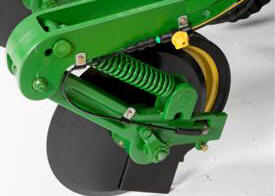 Orifice and check valve to the opener
Orifice and check valve to the opener
Delivering consistent and accurate fertilizer rates to each row is critical with any liquid fertilizer delivery system. The John Deere liquid fertilizer system utilizes 12-port block manifolds to equally distribute flow to the opener or in-furrow method of application. Liquid is distributed to each row through an 8-mm (0.3-in.) hose.
There are check valves at each row to ensure the system remains primed and flow stops immediately when planter is lifted. An orifice is located in-line and provides the restriction needed to achieve desired system pressure for excellent rate accuracy.
This delivery system will operate between 15 psi and 90 psi, depending on the orifice size and rate. System pressure should not exceed 100 psi. Four orifice sizes allow operators to achieve a variety of rates all with optimal system performance and row to row accuracy. See rate chart below for model by model minimum and maximum application rates.
An 80-mesh washable screen is in place between the tank and the pump. It is essential to have this screen (AA40216) and associated fittings in place ahead of the fertilizer pump even if not using a factory tank and quick-fill system. This screen is utilized to catch any blocks in the system caused by liquid fertilizer impurities. It is not recommended to use the 50-mesh screen.
 80-mesh screen and fittings
80-mesh screen and fittings

 Fertilizer rate chart located on planter
Fertilizer rate chart located on planter

Refer to this chart or the operator’s manual for fertilizer rate settings.
Model |
Maximum rate (gal./acre) |
Minimum rate (gal./acre) |
1705, 1715, 1725, 1755, 1765, 1775NT 12R, 1775NT 16R - 76 cm (30 in.) |
37.6 |
2.4 |
1705, 1715, 1755 - 91.44 cm (36 in.) |
31.3 |
2.0 |
1705, 1715, 1755 - 97 cm (38 in.) |
29.7 |
1.9 |
1705, 1715 - 102 cm (40 in.) |
28.2 |
1.8 |
1785 - 76.2 cm (30 in.) |
41.8 |
2.6 |
1785 - 91.44 cm (36 in.) |
34.8 |
2.2 |
1785 - 96.52 cm (38 in.) |
33.0 |
2.1 |
1775NT 24R Fixed-rate pump |
31.0 |
3.2 |
1795 |
28.4 |
3.3 |
DB44 24R22 |
20.0 |
4.0 |
DB58 32R22 |
14.0 |
4.0 |
DB60 24R30 |
14.0 |
3.0 |
DB60 47R15 |
14.0 |
5.0 |
DB60 36R20 |
14.0 |
4.0 |
DB66 36R22 |
12.0 |
4.0 |
DB80 48R20 |
10.0 |
4.0 |
DB88 48R22 |
10.0 |
4.0 |
DB90 36R30 |
8.0 |
3.0 |
DB80 32R30 |
8.0 |
3.0 |
DB120 48R30 |
7.0 |
3.0 |
NOTE: 1.2-mm (0.04-in.) yellow orifices and 1.7-mm (0.07-in.) black orifices are included with this system from the factory. For producers wanting to apply higher or lower application rates, two additional orifice sizes are available through Service Parts; 0.7-mm (0.03-in.) green (A91474) and 2.5-mm (1-in.) grey (A91478). Refer to rate charts in the operator’s manual or decal for details.
Field install kits
The John Deere liquid fertilizer system is also available as an attachment for field conversion on many models.
Fertilizer pump and opener options
 Fixed-rate CDS-John Blue® piston pump
Fixed-rate CDS-John Blue® piston pump

This liquid fertilizer delivery system is compatible with the fixed-rate pump. The system can be ordered with openers or less openers, if in-furrow application will be used. If ordered fewer openers, hoses with check valves and orifices installed will be tied up at each row for producers to finalize routing.
Flow monitor
If producers want to add a visual flow monitor to this system, John Deere has formed an allied agreement with CDS-John Blue to meet this need. Please contact CDS-John Blue for flow monitor options.
CDS-John Blue Company, Division of Advanced System Technology, Inc.
PO Box 1607, Huntsville, AL 35807
Tel: 800-253-2583, 256-721-9090
Fax: 256-721-9091
Email: info@cds-johnblue.com
www.cds-johnblue.com
CDS-John Blue is a trademark of CDS-John Blue Company.
 CDS-John Blue Visa Gage II liquid flow-rate monitor
CDS-John Blue Visa Gage II liquid flow-rate monitor
Granular fertilizer systems
Granular fertilizer hopper and transmission
 Granular fertilizer hopper and opener
Granular fertilizer hopper and opener
Granular fertilizer is available for 1755, 1775, and 1785 Planters. Fertilizer hoppers/tanks and selected other equipment may not be installed to facilitate shipping. Fertilizer attachments place fertilizer only on 76.2-, 91.4-, or 96.5-cm (30-, 36- or 38-in.) spacings. Some planter frame and row spacing combinations result in the opener offset from 10.1 to 15.2 cm (4 in. to 6 in.) of the centerline of the Tru-Vee™ opener.
Hoppers hold approximately 249.5 kg (550 lb) of fertilizer for longer operating time between fill-ups. One hopper feeds two rows. Hopper lids provide large opening for fast filling with less spillage. Hoppers pivot for easy dumping and cleaning.
Transmission (two on 1775) has 24 sprocket combinations in consistent 6 percent increments to allow applying fertilizer at the desired application rate. Depending on which auger is selected, a wide range of fertilizer rates can applied from 21 kg/ha (47 lb/acre) to 325 kg/ha (717 lb/acre). Requires openers or surface application bracket.
Augers for granular fertilizer system
Low-, regular-, or high-rate feed augers are required to complete the granular fertilizer system. Augers move fertilizer from the fertilizer boxes to the opener. Regular- or high-rate augers are matched with the opener style selected and are available as a factory-installed option or as an attachment for field conversion. Low-rate augers are only available as an attachment for field conversion.
For 30-in. rows the approximate rate of application is as follows
-
Low-rate augers 21.3-56.2 kg/ha (47 - 124 lb per acre)
-
Regular-rate augers 42.6-215.9 kg/ha (94 - 476 lb per acre)
-
High-rate augers 74.4 kg-325.2 kg/ha (164 - 717 lb per acre)
For 38 inch rows the approximate rate of application is as follows
-
Low-rate augers 16.8 kg-84.4 kg/ha (37 lb per acre-186 lb per acre)
-
Regular-rate augers 33.6 kg/ha-169.2 kg/ha (74 lb per acre-373 lb per acre)
-
High-rate augers 50.3 kg/ha-253.6 kg/ha (111 lb per acre-559 lb per acre)
NOTE: Weight metered may vary from that indicated because the fertilizer attachment will meter by volume not by weight and because of differences in fertilizer density
1755 and 1785 granular fertilizer openers
 Granular fertilizer opener
Granular fertilizer opener
Frame-mounted, double-disk openers and frame-mounted single-disk openers for granular fertilizer are available on the 1755 and 1785 Planters. The frame-mounted single-disk opener is available with a regular spout or cast spout. Fertilizer openers place the granular fertilizer into the soil for maximum plant uptake and are adjustable. Single-disk fertilizer openers are required for no-till, but are also suitable for conventional and reduced tillage. Double-disk fertilizer openers should only be used in conventional and reduced tillage conditions.
-
Single- and double-disk openers are compatible with frame-mounted coulters.
-
Single-disk opener with cast spout is recommended for all soil conditions because it keeps soil from flowing into the furrow before fertilizer is delivered.
-
Gauge wheel on single-disk openers will help gauge fertilizer application depth and minimize soil disruption.
-
On 1755 8Row30 Planters, due to frame limitations, the granular fertilizer systems with single-disk openers can place fertilizer no closer than 12.7 cm to 15.2 cm (5 in. to 6 in.) to the seed furrow on rows 4 and 5.
1770 granular fertilizer openers
Frame-mounted, single-disk fertilizer openers with cast spout are utilized on the 12Row30 1775 Planter. These openers are ideal for both conventional and no-till. The openers are adjustable to place the fertilizer in the soil next to the seed furrow for ideal nutrient placement and maximum plant uptake. A single gauge wheel allows the opener to follow the contour of the ground for ideal fertilizer depth placement. Single-disk fertilizer openers are compatible with frame-mounted coulters.
Pneumatic downforce system
Pneumatic downforce provides convenient, simple adjustment of downforce for the whole planter from one location. The amount of downforce applied is infinitely adjustable from 0 kg to 181.80 kg (0 lb to 400 lb). Pneumatic downforce provides more consistent downforce throughout the range of row-unit travel than mechanical spring downforce systems.
Several pneumatic downforce system improvements have been implemented, including:
- 9.5-mm (3/8-in.) air delivery line instead of the 6.4-mm (1/4-in.) line used on model year 2010 and older planters.
- Air compressor assembly increased duty cycle. With this compressor, it provides a 47 percent increase in maximum air flow delivery compared to the prior air compressor.
- Pneumatic air bags with 9.5-mm (3/8-in.) air line inlets that have greater durability.
Such improvements to the pneumatic downforce system enable faster and more precise control of row-unit downforce while planting.
System features
 Pneumatic downforce spring
Pneumatic downforce spring

Each row-unit has a single, rubber air bag located between the parallel arms. The air bags are hooked in parallel so that air can be added or released from all rows at once from one location.
Pneumatic downforce systems are available as base equipment on all 1700 Series and DB Planters. The individual pneumatic downforce air bag assemblies, air compressor units, and 9.5-mm (3/8-in.) delivery lines are also available as an attachment for field conversion.
 Pneumatic downforce compressor and gauge
Pneumatic downforce compressor and gauge

An improved compressor is used to charge the pneumatic system. This compressor can be located on the planter frame or in the tractor cab if desired. A gauge at the compressor indicates the amount of downforce being applied.
From the factory, integral planter models with pneumatic downforce will have an improved air compressor assembly with an in-cab mounting bracket, except the 1725 16-row and 1725 Central Commodity System (CCS™ ) Twin-Row Planters will have the air compressor assembly mounted on the planter frame. For drawn planter models, the 1755, 1765, 1765NT, 1775 Front-Fold, and 1785 Drawn Planters will have the air compressor assembly installed either on the outer hitch or wing frame members when the pneumatic downforce system is installed.
Row cleaner options to meet residue management needs
Crop yields have increased through the years along with the amount of residue left in the field after harvest. At the same time, tillage practices have changed, including different tillage operations which maintain large amounts of surface residue, and even no till practices. Row cleaners are an essential tool in managing this increased amount of residue.
John Deere seeding group offers a variety of row cleaner options to meet the needs of a producer's operation. Compatibility varies by model, row spacing, and other planter equipment.
Screw-adjust unit-mounted row cleaner
 Screw-adjust unit-mounted row cleaner
Screw-adjust unit-mounted row cleaner
The screw-adjust unit-mounted row cleaner is mounted directly to the face plate of the row-unit, placing the ground engaging components just in front of the row-unit opener blades and depth gauge wheels. This close proximity allows the gauge wheels to control the depth of the row cleaner as well as the row-unit. This compact design also allows greater compatibility with fertilizer openers and other planter attachments.
SharkTooth® wheels are standard equipment on the unit-mounted row cleaner. The swept-tooth design of the wheel provides a clear path for the row-unit openers while resisting residue buildup on the wheel. The screw adjustment knob is accessible through the top of the parallel arms, providing convenient access for adjustments. The row cleaner can be adjusted in 1.6-mm (0.06-in.) increments, providing plenty of flexibility to meet the needs of changing conditions.
Floating row cleaner with unit-mounted coulter
 Floating row cleaner with unit-mounted coulter
Floating row cleaner with unit-mounted coulter
The floating row cleaner allows a row cleaner to be used in conjunction with a unit-mounted coulter. This combination is often desired in heavy residue loads and tough reduced tillage planting conditions. The row cleaner provides a clear path for the row-unit, while the unit-mounted coulter helps penetrate tough soil conditions.
Accommodating the unit-mounted coulter means the residue wheels are farther forward from the row-unit face plate than in the case of the screw adjust row cleaner. To maintain performance, this row cleaner has the capability to float above a defined minimum depth.
Standard depth-gauging bands on the wheels allow the row cleaner wheels to float independently of the row unit openers, allowing both to perform in varying terrain. The unit may also be set in a fixed position by simply pinning through the bracket if desired. This row cleaner also features SharkTooth wheels as standard equipment.
The floating row cleaner and unit-mounted coulters are available on many planters as factory-installed equipment. As compatibility and details vary by model, review the following links for information on specific planter models.
SharkTooth is a trademark of Yetter Manufacturing.
NOTE: Screw-adjust row cleaners are not compatible with MaxEmerge™ 5e row-units with long parallel arms.
NOTE: DB models have the option for either unit-mounted coulter, screw-adjust row cleaners, or pneumatic row cleaners (only compatabile with MaxEmerge 5e or equipped ExactEmerge™ models). The DB60T is only available with less row cleaner option.
Seed variable-rate drive
Seed variable-rate drive provides the ultimate planting productivity by utilizing one, two, or three hydraulic motors (varies by model) to turn the seeding drive shaft. Hydraulic control of the seeding drive allows for on-the-go seeding rate changes right from the display mounted inside the tractor cab. Combine this seeding flexibility with the map-based planting option, and seeding rates adjust automatically based on the prescribed map.
Variable-rate drive offers the following advantages over common, ground, or contact-tire drive systems:
-
Rate changes are almost instantaneous; no ramp up or ramp down of system as in some competitive systems
- Permits the producer to match seed population based on different soil types or irrigation practices
- John Deere design provides added operator safety by eliminating any possible drive creep found in some competitive variable-rate drive systems
 1755 equipped with variable-rate drive
1755 equipped with variable-rate drive
 1765NT equipped with variable-rate drive
1765NT equipped with variable-rate drive
Single- or dual-motor systems for variable-rate drives are available for all John Deere planters except the 1785 Rigid Frame. Variable-rate drive is available as a factory-installed option for all applicable planter models.
Single- or dual-motor systems are available as field-installed attachments for most planter models; however, a three-motor variable-rate drive field-installed attachment is not available.
Seed variable-rate drive requires the SeedStar™ monitor and a radar input signal. Either tractor or planter radar may be used. Planter radar is ordered separately.
NOTE: Peanut seed meter disks require the Variable Drive Transmission.
Features
MegaWide™ pickup with MegaTough™ pickup teeth provide added durability
 MegaWide pickup
MegaWide pickup
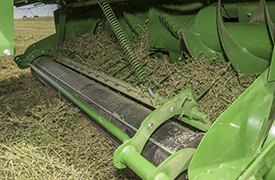 MegaWide pickup
MegaWide pickup
The pickup is designed and built by John Deere in Ottumwa, Iowa. The John Deere MegaWide large square balers (LSBs) pickups use a low-profile pickup drum with a large-diameter roller baffle to efficiently pick crop up from the field. The performance of the roller baffle compressing the crop against the pickup tines means more crop in the bale and fewer leaves and crop left in the field.
- 2.2-m (7.2-ft) wide pickup is available on the L331 and L341 Baler
- Available with standard or premium components
- Tooth-to-tooth width is 1.92 m (76 in.)
- Eight staggered tooth bars help prevent overload
- Standard semi-pneumatic fixed gauge wheels provide smooth ground gauging over uneven terrain and protection to the pickup
- 2.5-m (8.1-ft) wide pickup is available on the L341 Baler
- Available only with premium components
- Tooth-to-tooth width is 2.18 m (86 in.)
- Eight staggered tooth bars help prevent overload
- Standard semi-pneumatic pivoting gauge wheels reduce sliding and scuffing of the tires in the field when the baler turns
- MegaWide pickup makes it easier to produce better-shaped bales and improves crop pickup in wide, windblown, or scattered windrows
- MegaTough pickup teeth provide greater strength and durability
- Chain driven for positive feeding
- Mechanical cutout clutch protection for added durability
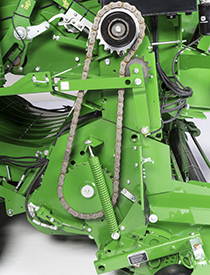
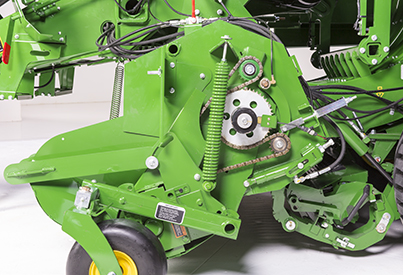
 MegaTough pickup teeth
MegaTough pickup teeth
Mega and MegaTough pickup teeth are base equipment:
- Mega pickup teeth, at the ends of the pickup, are heavy-duty for long life and improved crop retrieval
- MegaTough pickup teeth are designed to withstand the harshest baling conditions and provide long service life
Both pickup widths use a heavy, C-channel construction for the toothbar assembly. The pickup toothbars are divided into two half sections that mount to a center spider for increased strength and even crop feeding.
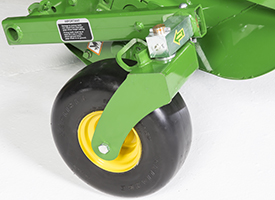 Semi-pneumatic gauge wheels
Semi-pneumatic gauge wheels
Semi-pneumatic gauge wheels provide smooth ground gauging over uneven terrain and protection to the pickup.
- Stiffer rubber sidewalls
- No air pressure to maintain, which means no flat tires
- Adjustable to meet pickup tooth-to-stubble height requirements
Converging wheels are available on the 2.2-m (7.2-ft) pickup to increase the overall feeding width to 2.8 m (9.2 ft):
- Rubber-mounted steel tines offer better durability
- Tines are sized to prevent dirt buildup
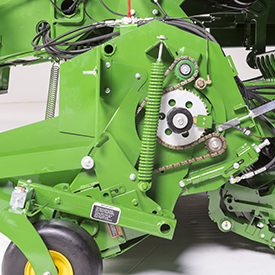 Pickup float springs
Pickup float springs
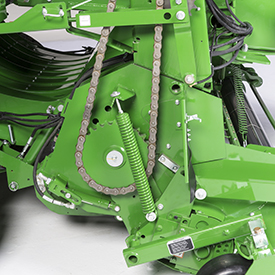 Pickup float springs
Pickup float springs
The pickup float springs are positioned for excellent flotation.
- Adjustable to meet varying field conditions
- Float springs only support the pickup reel
- Rotor assembly is fixed to the baler frame, eliminating additional weight on the pickup system
Premium MegaWide™ pickup
The premium MegaWide pickup is available for the L331 and L341 Large Square Balers. The premium pickup offers larger components to increase the durability and reliability of the pickup.
Changes to the premium Megawide pickup include:
- Larger cams and cam bearings
- Larger spider gears
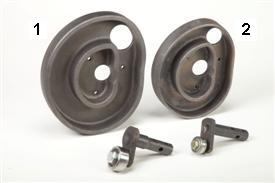 Reel cam and cam arms for premium machines
Reel cam and cam arms for premium machines
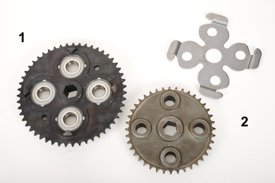 Left-hand spider gears
Left-hand spider gears
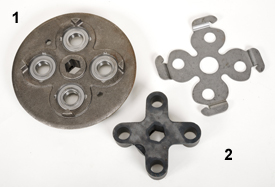 Right-hand spider gears
Right-hand spider gears
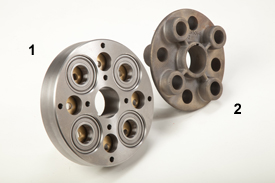
The spider gears on the premium pickup have bearings that give the reel increased durability (longer life), as well as offering a more quiet operation of the pickup. The spider gears are also larger in diameter for increased life.
Double-tie knotter system provides reliable knotting in high density and the most difficult baling conditions
 Double-tie knotter system
Double-tie knotter system
 Knotter grease block
Knotter grease block
L331 and L341 Large Square Balers (LSBs) come standard with double-tie knotters.
John Deere-designed knotters are designed for performance, reliability, and reduced maintenance requirements. The auto-lube system is integrated into the knotter frames, and two internal grease ports reduce the time spent on pre-baling maintenance.
Integration of the lube system block into the knotter frame reduces the number of grease lines required for each knotter.
The integrated grease block results in a reduction in the amount of grease lines required to grease the knotter system and the number of grease line connection points. Fewer feet of grease lines and fewer connection points mean less maintenance and more time baling.
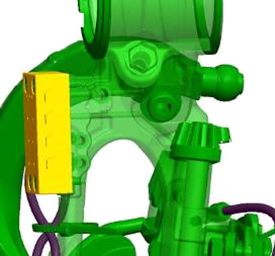 Knotting system
Knotting system
If service to the knotter stack is required, the knotters are positioned using an adjustment screw instead of shims. This saves time by having the ability to make adjustments at any point of assembly.
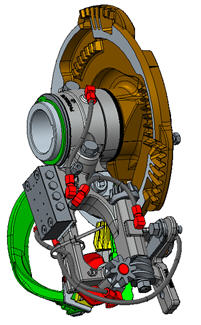 Split-frame knotter
Split-frame knotter
The split-knotter frame is directly mounted to the intermittent gear so the frame can be removed without servicing the knotter stack.
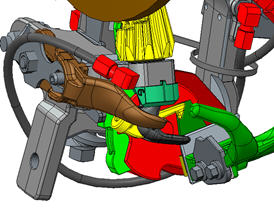 Billhook cam
Billhook cam
Like the John Deere single-tie knotter, the billhook cam and wiper arm plate are removable and individually serviceable. This allows replacement without replacing large castings or assemblies.
Instances where competitors must adjust the wiper arm to the billhook with a hammer, the John Deere solution allows the setting to be made with two bolts. This provides a more precise and repeatable setting, which results in more consistent knot wipe-offs.
| L331 | L341 | |
| Connection point reduction | 8 | 12 |
| Lube line reduction (m, ft) | 16.8 m (55 ft) |
25.3 m (83 ft) |
The one series LSBs store twine in single-row twine boxes. The twine is then routed to the sealed gear tensioners. The sealed tensioner gears have been proven to provide more consistent twine tension during knot formation. This increases knotter performance and consistency. Once the correct bale length is achieved, the tie system clutch is activated.
Knotter trip system
The John Deere-designed double-tie knotting system is gear and driveline driven to ensure the needle-to-plunger timing is maintained throughout the life of the baler.
The needle lift crank and clutch rocker arm are made of hardened cast iron to improve strength and durability of the knotter clutch. The gearbox drives the system around 360 degrees to complete a tie.
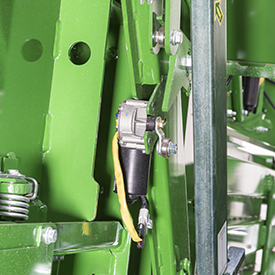 Knotter trip system
Knotter trip system
On the L331 and L341 Large Square Balers, the producer can choose between a mechanical trip system or an electrical trip system.
The electrical trip system offers the following advantages:
- Bale length adjustment from the cab
- Tying off the last bale from the cab
- Reduction in maintenance requirements
- Improved length accuracy
- Predictive tie
- Predictive tie takes into account the flake size throughout the bale and desired length of bale. When a bale is approaching the desired length and the next flake will put it at or over the desired length, predictive tie will trip the tie system. Whereas the mechanical system has to pass the desired length then it will tie on the next flake.
Baler monitor system is International Standard Organization Bus (ISOBUS) compatible

John Deere large square balers (LSBs) are ISOBUS compatible which enables them to work with any ISOBUS monitor system.
Baler control can also be incorporated into the CommandCenter™ on R Series Tractors as long as the tractor is ordered ISOBUS ready (GS-ready wiring harness option code 8064 or GS AutoTrac™-ready wiring harness option code 8067on 6R Tractors).
Current GreenStar™ (GS) displays, including the touchscreen 2630, 1800 as well as the GS 2600, are compatible for customers who already own a John Deere ISOBUS display.
The display main screen is user selectable allowing for customization so the customer sees what they want where they want. With more information available from the moisture and weighing systems the operator can select what they care most about.
The new menu is controlled over what softkeys are shown on the main page allowing users to navigate to what they need faster and easier.
Balers that will be utilized on non-ISO tractors will require a GS display as well as a conversion harness to connect the display and the baler.
One series LSBs offer a manual pressure control mode, allowing the operator to continue baling in the event of an electrical failure.
Information and adjustments available on the display:
- Driving direction arrows are shown across the top of the screen, helping the operator create a more uniform bale.
- Electronic knotter flags are standard on all John Deere balers. This feature offers convenience to operators by allowing for true look-ahead baling.
- Feedback on the flywheel brake, precutter functions (if equipped), greasing, lighting, bale chute (if equipped), and bale drop (if equipped) systems.
- Bale weights and bale moisture are displayed when their respective options are purchased.
- Control of the drop floor on the precutter rotor option.
- Electronic tie control from the cab.
- Preservative applicator monitoring and adjustments.
- Machine faults are shown in red on the screen allowing the user to quickly detect any issues.
- Bale count is selectable between the current field, customer, season, or lifetime bale counts.
PhiBer accumulator integration into the baler display.
PhiBer is a trademark of PhiBer Manufacturing Inc.
Moisture sensor
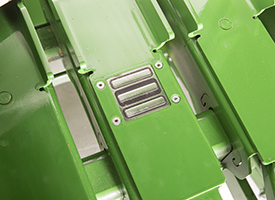 Moisture sensor
Moisture sensor
The John Deere integrated moisture sensor for large square balers provides bale moisture levels throughout the baling process. Mounted forward in the bale chamber, it provides timely information for real-time decisions. This sensor was designed by John Deere specifically for the application, and uses an integrated display for less clutter in the cab. It operates in a complete range of moistures from dry to wet crops.
This sensor can be used in conjunction with the John Deere preservative system to adjust application rates.
Weighing system
The John Deere bale weighing system provides bale weights throughout the baling process. With sensors mounted to the pre-compression chamber floor, it provides bale weights on a flake-by-flake basis. Knowing the flake weight helps the operator make more consistent bales. The current bale weight and previous bale weights can be displayed on the monitor.
Preservative applicator
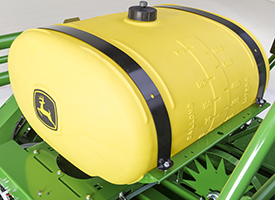 Preservative tank
Preservative tank
Preservative application allows harvesting hay at slightly higher moisture levels without worrying about spoilage or heat. Using preservative increases the baling window by allowing operators to begin baling earlier in the day and continue baling later into the evening, this greatly decreases the dependency on weather. This application system is capable of preserving hay up to a 27 percent moisture level without compromising hay quality.
NOTE: Care must be exercised not to exceed the moisture levels recommended by preservative manufacturers in order to avoid spoilage.
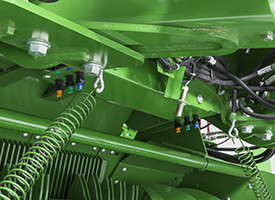 Crop detection sensors
Crop detection sensors
The one series LSB offers a John Deere designed preservative application system. The John Deere system is integrated with the John Deere moisture sensor. The high-accuracy moisture sensor enables more accurate application of preservative. Crop detection sensors detect crop to ensure that preservative is only being applied when crop is present.
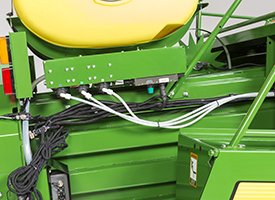 Preservative system installation
Preservative system installation
Factory installation of the preservative system is available and eliminates any baler modifications that were previously required when performing a dealer installation. The factory installation tests all electrical components of the preservative system before it leaves the factory.
The preservative applicator includes the following:
- 567-L (150-U.S. gal.) poly tank 12-V diaphragm-type pump
- Integration into John Deere electronics
- Service parts available through the John Deere Dealer Network
BalerAssist

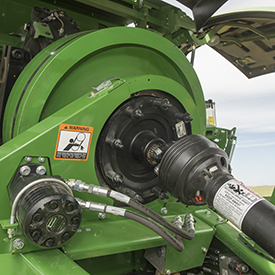
The BalerAssist drivetrain system is an industry-exclusive offering that gives the operator the ability to hydraulically control the drivetrain. The system is able to operate in both the forward direction as well as the reverse direction and at two speeds each direction with a maximum speed of about 4 plunger strokes per minute.
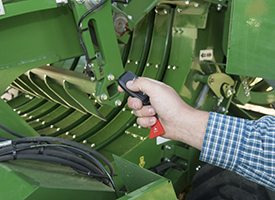
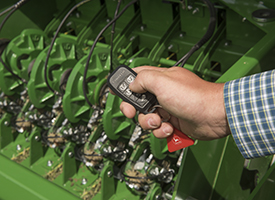
John Deere value:
- Reduced time to remove plugs that occur in the pickup or rotor by backing the plug out
- Reduced time to perform maintenance and time the baler
- Increased ability to troubleshoot knotters by performing slower tie cycles
The BalerAssist drivetrain system can be controlled from the display or from a Bluetooth® wireless system remote.
- Once BalerAssist is enabled from the display, it can be controlled by the Bluetooth remote
- Bluetooth remote is included when the option is ordered
From the display, speed adjustments can be made to the following categories:
- Slow forward
- Fast forward
- Slow reverse
- Fast reverse
 BalerAssist Bluetooth remote
BalerAssist Bluetooth remote
The Bluetooth remote has the following functions with icons that match the display:
- Enable
- Slow forward
- Fast forward
- Slow reverse
- Fast reverse
- Service lights can be turned on using the remote
Bluetooth is a trademark of Bluetooth SIG Incorporated.
Wear parts box
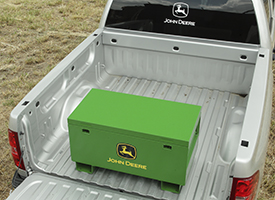
A wear parts box will be available for the L331 and L341 Large Square Balers (LSBs). The wear parts box includes 18 of the most common wear parts identified by customer support and engineering. Having these parts on hand will help producers keep their balers running during the season. The parts box is an option that can be ordered when configuring the baler.
NOTE: The wear parts box is for the one series baler. A lot of the parts included in the box are not able to be retrofit to the L330 or L340.
Parts come packaged in a durable container that can be used in the truck, shop, or field.
Magnetic parts lists help producers keep track of parts they need.
Parts included:
| Part | Quantity |
| Pickup teeth | 20 |
| Pickup strippers | 4 |
| Pickup stripper bolts | 4 |
| Left-hand cam arm | 1 |
| Right-hand cam arm | 1 |
| Cam arm bearing | 4 |
| Cam arm bolt | 2 |
| Bill hooks | 6 |
| Wiper plates | 6 |
| Twine knives | 6 |
| Twine discs | 3 |
| Twine retainer | 3 |
| Twine cleaner | 3 |
| Needle roller kit | 6 |
| Proximity sensor | 2 |
| Bottom knives bolts | 6 |
| Bottom knives center | 2 |
| Bottom knives end | 1 |
Bale Mobile app provides more information to enable better decisions

Similar yield data that has been available for crops like corn and soybeans is now available for hay, thanks to the large square balers and the Bale Mobile app. The One Series Large Square Balers measure moisture and weight for each bale. This app takes that real-time information to a whole new level, whether baling, loading, or in the office managing.
Baling
The operator in the tractor can see information as the app documents the baling process. The moisture and weight are tagged to the individual bale. If a bale is too wet, the operator can immediately decide whether to apply preservative or even stop baling. Bale Mobile also has the option to tag bales so they can be easily identified when sorting. After baling in a field, a summary will show the crop, number of bales, and average moisture, even if there is more than one baler running.
Loading and moving bales
When loading trucks or moving bales, Bale Mobile uses this same data to help plan more efficiently. It gives users the option to sort by moisture, weight, and if preservative has or has not been applied. It will help keep the wet or weedy bales out of the stack and load trucks for optimal weight.
Management
From the office, producers can see where the balers are and how well they are working while managing operations and making sound decisions. A summary will show yield information by field to help decide on irrigation, fertilizer, or replanting before next season. This documentation can even be shared with landlords and trusted advisors.
From baling to loading and planning, the John Deere Bale Mobile app allows producers to get more information, improve efficiency, and make better decisions.
Hardware and compatibility requirements:
- iPad® tablet
- One Series Large Square Baler
- Hardware kit
- Dealer installation for model year 2018
- Factory installation for model year 2019
- Tractor with StarFire™ receiver
- No subscription fee required
To order the BaleMobile through the parts system, use bundle number BE32776.
Note: BaleMobile is only available on the 1-Series large square balers, and requires the baler to be equipped with the mass flow and moisture sensors
iPad is a trademark of Apple Inc.
Features
MegaWide™ pickup with MegaTough™ pickup teeth provide added durability
 MegaWide pickup
MegaWide pickup
 MegaWide pickup
MegaWide pickup
The pickup is designed and built by John Deere in Ottumwa, Iowa. The John Deere MegaWide large square balers (LSBs) pickups use a low-profile pickup drum with a large-diameter roller baffle to efficiently pick crop up from the field. The performance of the roller baffle compressing the crop against the pickup tines means more crop in the bale and fewer leaves and crop left in the field.
- 2.2-m (7.2-ft) wide pickup is available on the L331 and L341 Baler
- Available with standard or premium components
- Tooth-to-tooth width is 1.92 m (76 in.)
- Eight staggered tooth bars help prevent overload
- Standard semi-pneumatic fixed gauge wheels provide smooth ground gauging over uneven terrain and protection to the pickup
- 2.5-m (8.1-ft) wide pickup is available on the L341 Baler
- Available only with premium components
- Tooth-to-tooth width is 2.18 m (86 in.)
- Eight staggered tooth bars help prevent overload
- Standard semi-pneumatic pivoting gauge wheels reduce sliding and scuffing of the tires in the field when the baler turns
- MegaWide pickup makes it easier to produce better-shaped bales and improves crop pickup in wide, windblown, or scattered windrows
- MegaTough pickup teeth provide greater strength and durability
- Chain driven for positive feeding
- Mechanical cutout clutch protection for added durability


 MegaTough pickup teeth
MegaTough pickup teeth
Mega and MegaTough pickup teeth are base equipment:
- Mega pickup teeth, at the ends of the pickup, are heavy-duty for long life and improved crop retrieval
- MegaTough pickup teeth are designed to withstand the harshest baling conditions and provide long service life
Both pickup widths use a heavy, C-channel construction for the toothbar assembly. The pickup toothbars are divided into two half sections that mount to a center spider for increased strength and even crop feeding.
 Semi-pneumatic gauge wheels
Semi-pneumatic gauge wheels
Semi-pneumatic gauge wheels provide smooth ground gauging over uneven terrain and protection to the pickup.
- Stiffer rubber sidewalls
- No air pressure to maintain, which means no flat tires
- Adjustable to meet pickup tooth-to-stubble height requirements
Converging wheels are available on the 2.2-m (7.2-ft) pickup to increase the overall feeding width to 2.8 m (9.2 ft):
- Rubber-mounted steel tines offer better durability
- Tines are sized to prevent dirt buildup
 Pickup float springs
Pickup float springs
 Pickup float springs
Pickup float springs
The pickup float springs are positioned for excellent flotation.
- Adjustable to meet varying field conditions
- Float springs only support the pickup reel
- Rotor assembly is fixed to the baler frame, eliminating additional weight on the pickup system
Premium MegaWide™ pickup
The premium MegaWide pickup is available for the L331 and L341 Large Square Balers. The premium pickup offers larger components to increase the durability and reliability of the pickup.
Changes to the premium Megawide pickup include:
- Larger cams and cam bearings
- Larger spider gears
 Reel cam and cam arms for premium machines
Reel cam and cam arms for premium machines
 Left-hand spider gears
Left-hand spider gears
 Right-hand spider gears
Right-hand spider gears

The spider gears on the premium pickup have bearings that give the reel increased durability (longer life), as well as offering a more quiet operation of the pickup. The spider gears are also larger in diameter for increased life.
Double-tie knotter system provides reliable knotting in high density and the most difficult baling conditions
 Double-tie knotter system
Double-tie knotter system
 Knotter grease block
Knotter grease block
L331 and L341 Large Square Balers (LSBs) come standard with double-tie knotters.
John Deere-designed knotters are designed for performance, reliability, and reduced maintenance requirements. The auto-lube system is integrated into the knotter frames, and two internal grease ports reduce the time spent on pre-baling maintenance.
Integration of the lube system block into the knotter frame reduces the number of grease lines required for each knotter.
The integrated grease block results in a reduction in the amount of grease lines required to grease the knotter system and the number of grease line connection points. Fewer feet of grease lines and fewer connection points mean less maintenance and more time baling.
 Knotting system
Knotting system
If service to the knotter stack is required, the knotters are positioned using an adjustment screw instead of shims. This saves time by having the ability to make adjustments at any point of assembly.
 Split-frame knotter
Split-frame knotter
The split-knotter frame is directly mounted to the intermittent gear so the frame can be removed without servicing the knotter stack.
 Billhook cam
Billhook cam
Like the John Deere single-tie knotter, the billhook cam and wiper arm plate are removable and individually serviceable. This allows replacement without replacing large castings or assemblies.
Instances where competitors must adjust the wiper arm to the billhook with a hammer, the John Deere solution allows the setting to be made with two bolts. This provides a more precise and repeatable setting, which results in more consistent knot wipe-offs.
| L331 | L341 | |
| Connection point reduction | 8 | 12 |
| Lube line reduction (m, ft) | 16.8 m (55 ft) |
25.3 m (83 ft) |
The one series LSBs store twine in single-row twine boxes. The twine is then routed to the sealed gear tensioners. The sealed tensioner gears have been proven to provide more consistent twine tension during knot formation. This increases knotter performance and consistency. Once the correct bale length is achieved, the tie system clutch is activated.
Knotter trip system
The John Deere-designed double-tie knotting system is gear and driveline driven to ensure the needle-to-plunger timing is maintained throughout the life of the baler.
The needle lift crank and clutch rocker arm are made of hardened cast iron to improve strength and durability of the knotter clutch. The gearbox drives the system around 360 degrees to complete a tie.
 Knotter trip system
Knotter trip system
On the L331 and L341 Large Square Balers, the producer can choose between a mechanical trip system or an electrical trip system.
The electrical trip system offers the following advantages:
- Bale length adjustment from the cab
- Tying off the last bale from the cab
- Reduction in maintenance requirements
- Improved length accuracy
- Predictive tie
- Predictive tie takes into account the flake size throughout the bale and desired length of bale. When a bale is approaching the desired length and the next flake will put it at or over the desired length, predictive tie will trip the tie system. Whereas the mechanical system has to pass the desired length then it will tie on the next flake.
Baler monitor system is International Standard Organization Bus (ISOBUS) compatible

John Deere large square balers (LSBs) are ISOBUS compatible which enables them to work with any ISOBUS monitor system.
Baler control can also be incorporated into the CommandCenter™ on R Series Tractors as long as the tractor is ordered ISOBUS ready (GS-ready wiring harness option code 8064 or GS AutoTrac™-ready wiring harness option code 8067on 6R Tractors).
Current GreenStar™ (GS) displays, including the touchscreen 2630, 1800 as well as the GS 2600, are compatible for customers who already own a John Deere ISOBUS display.
The display main screen is user selectable allowing for customization so the customer sees what they want where they want. With more information available from the moisture and weighing systems the operator can select what they care most about.
The new menu is controlled over what softkeys are shown on the main page allowing users to navigate to what they need faster and easier.
Balers that will be utilized on non-ISO tractors will require a GS display as well as a conversion harness to connect the display and the baler.
One series LSBs offer a manual pressure control mode, allowing the operator to continue baling in the event of an electrical failure.
Information and adjustments available on the display:
- Driving direction arrows are shown across the top of the screen, helping the operator create a more uniform bale.
- Electronic knotter flags are standard on all John Deere balers. This feature offers convenience to operators by allowing for true look-ahead baling.
- Feedback on the flywheel brake, precutter functions (if equipped), greasing, lighting, bale chute (if equipped), and bale drop (if equipped) systems.
- Bale weights and bale moisture are displayed when their respective options are purchased.
- Control of the drop floor on the precutter rotor option.
- Electronic tie control from the cab.
- Preservative applicator monitoring and adjustments.
- Machine faults are shown in red on the screen allowing the user to quickly detect any issues.
- Bale count is selectable between the current field, customer, season, or lifetime bale counts.
PhiBer accumulator integration into the baler display.
PhiBer is a trademark of PhiBer Manufacturing Inc.
Moisture sensor
 Moisture sensor
Moisture sensor
The John Deere integrated moisture sensor for large square balers provides bale moisture levels throughout the baling process. Mounted forward in the bale chamber, it provides timely information for real-time decisions. This sensor was designed by John Deere specifically for the application, and uses an integrated display for less clutter in the cab. It operates in a complete range of moistures from dry to wet crops.
This sensor can be used in conjunction with the John Deere preservative system to adjust application rates.
Weighing system
The John Deere bale weighing system provides bale weights throughout the baling process. With sensors mounted to the pre-compression chamber floor, it provides bale weights on a flake-by-flake basis. Knowing the flake weight helps the operator make more consistent bales. The current bale weight and previous bale weights can be displayed on the monitor.
Preservative applicator
 Preservative tank
Preservative tank
Preservative application allows harvesting hay at slightly higher moisture levels without worrying about spoilage or heat. Using preservative increases the baling window by allowing operators to begin baling earlier in the day and continue baling later into the evening, this greatly decreases the dependency on weather. This application system is capable of preserving hay up to a 27 percent moisture level without compromising hay quality.
NOTE: Care must be exercised not to exceed the moisture levels recommended by preservative manufacturers in order to avoid spoilage.
 Crop detection sensors
Crop detection sensors
The one series LSB offers a John Deere designed preservative application system. The John Deere system is integrated with the John Deere moisture sensor. The high-accuracy moisture sensor enables more accurate application of preservative. Crop detection sensors detect crop to ensure that preservative is only being applied when crop is present.
 Preservative system installation
Preservative system installation
Factory installation of the preservative system is available and eliminates any baler modifications that were previously required when performing a dealer installation. The factory installation tests all electrical components of the preservative system before it leaves the factory.
The preservative applicator includes the following:
- 567-L (150-U.S. gal.) poly tank 12-V diaphragm-type pump
- Integration into John Deere electronics
- Service parts available through the John Deere Dealer Network
BalerAssist


The BalerAssist drivetrain system is an industry-exclusive offering that gives the operator the ability to hydraulically control the drivetrain. The system is able to operate in both the forward direction as well as the reverse direction and at two speeds each direction with a maximum speed of about 4 plunger strokes per minute.


John Deere value:
- Reduced time to remove plugs that occur in the pickup or rotor by backing the plug out
- Reduced time to perform maintenance and time the baler
- Increased ability to troubleshoot knotters by performing slower tie cycles
The BalerAssist drivetrain system can be controlled from the display or from a Bluetooth® wireless system remote.
- Once BalerAssist is enabled from the display, it can be controlled by the Bluetooth remote
- Bluetooth remote is included when the option is ordered
From the display, speed adjustments can be made to the following categories:
- Slow forward
- Fast forward
- Slow reverse
- Fast reverse
 BalerAssist Bluetooth remote
BalerAssist Bluetooth remote
The Bluetooth remote has the following functions with icons that match the display:
- Enable
- Slow forward
- Fast forward
- Slow reverse
- Fast reverse
- Service lights can be turned on using the remote
Bluetooth is a trademark of Bluetooth SIG Incorporated.
Wear parts box

A wear parts box will be available for the L331 and L341 Large Square Balers (LSBs). The wear parts box includes 18 of the most common wear parts identified by customer support and engineering. Having these parts on hand will help producers keep their balers running during the season. The parts box is an option that can be ordered when configuring the baler.
NOTE: The wear parts box is for the one series baler. A lot of the parts included in the box are not able to be retrofit to the L330 or L340.
Parts come packaged in a durable container that can be used in the truck, shop, or field.
Magnetic parts lists help producers keep track of parts they need.
Parts included:
| Part | Quantity |
| Pickup teeth | 20 |
| Pickup strippers | 4 |
| Pickup stripper bolts | 4 |
| Left-hand cam arm | 1 |
| Right-hand cam arm | 1 |
| Cam arm bearing | 4 |
| Cam arm bolt | 2 |
| Bill hooks | 6 |
| Wiper plates | 6 |
| Twine knives | 6 |
| Twine discs | 3 |
| Twine retainer | 3 |
| Twine cleaner | 3 |
| Needle roller kit | 6 |
| Proximity sensor | 2 |
| Bottom knives bolts | 6 |
| Bottom knives center | 2 |
| Bottom knives end | 1 |
Bale Mobile app provides more information to enable better decisions

Similar yield data that has been available for crops like corn and soybeans is now available for hay, thanks to the large square balers and the Bale Mobile app. The One Series Large Square Balers measure moisture and weight for each bale. This app takes that real-time information to a whole new level, whether baling, loading, or in the office managing.
Baling
The operator in the tractor can see information as the app documents the baling process. The moisture and weight are tagged to the individual bale. If a bale is too wet, the operator can immediately decide whether to apply preservative or even stop baling. Bale Mobile also has the option to tag bales so they can be easily identified when sorting. After baling in a field, a summary will show the crop, number of bales, and average moisture, even if there is more than one baler running.
Loading and moving bales
When loading trucks or moving bales, Bale Mobile uses this same data to help plan more efficiently. It gives users the option to sort by moisture, weight, and if preservative has or has not been applied. It will help keep the wet or weedy bales out of the stack and load trucks for optimal weight.
Management
From the office, producers can see where the balers are and how well they are working while managing operations and making sound decisions. A summary will show yield information by field to help decide on irrigation, fertilizer, or replanting before next season. This documentation can even be shared with landlords and trusted advisors.
From baling to loading and planning, the John Deere Bale Mobile app allows producers to get more information, improve efficiency, and make better decisions.
Hardware and compatibility requirements:
- iPad® tablet
- One Series Large Square Baler
- Hardware kit
- Dealer installation for model year 2018
- Factory installation for model year 2019
- Tractor with StarFire™ receiver
- No subscription fee required
To order the BaleMobile through the parts system, use bundle number BE32776.
Note: BaleMobile is only available on the 1-Series large square balers, and requires the baler to be equipped with the mass flow and moisture sensors
iPad is a trademark of Apple Inc.
Features
Versatile, productive, and durable premium pickup
Cam-track design offers the best versatility
 Left, pickup with cam track; right, cam-less pickup
Left, pickup with cam track; right, cam-less pickup
Versatility has been one of the key criteria when designing the R-Series Balers. Due to a narrow weather window and increasing amounts of difficult crops, such as heavy silage, growers do not want to risk losing any more time during the season.
Cam-track technology provides an efficient solution for such needs. The traditional stripper design provides reduced space between the pickup tines and rotor feeder, while the tine motion helps to avoids pinching.
The cam-less technology requires long strippers, creating a dead zone between the tines and rotor. Additionally, fixed tines can easily pinch crops in sticky conditions, causing plugs that need to be manually removed.
Looking at potential component wear, the cam-track pickup features a low turning speed and big bearings on both side of the tine bars. Also, the cam lever is made of forged steel. These features guarantee a long component life and low maintenance.
Premium pickup pushes harvesting capacity a step forward
 Premium – five tine bars – pickup
Premium – five tine bars – pickup
 Tine bars made of tube and central spider reinforcement
Tine bars made of tube and central spider reinforcement
R-Series Balers are designed for the most demanding operators. The pickup features only premium components and concepts such as:
- 2.20-m (7.2-ft) wide pickup, with a 1.92-m (6.3-ft) tine-to-tine distance - this important width provides comfort and speed capacity when harvesting the largest swaths.
- Five tine bars - the fifth bar allows the tines to rake two more times per second versus the John Deere standard four-tine pickup.
- O-shaped tubular tine bars with central spider reinforcement - tines bars are assembled with ball bearings on the central spider, and central spiders highly limit tine bars bending in the very heavy crops.
- 6.0-mm (0.23-in.) diameter galvanized tines with high strength to harvest the toughest crops.
- Tines are designed to fold to replace potential shear bolt or cam clutch overload safety. 6.0-mm (0.23-in.) diameter tine push pickup maximum intake capacity up to 18 kW (24.1 hp), a value often not reached by machines using cam or shear bolt protected pickup.
- Stainless-steel strippers (exclusive feature) that give highly durable rust protection, perfect gliding capacity no matter the material, and is much more resistant to acid damage caused by additive uses (propionic acid).
High-Capacity (HC) Premium rotors grab the toughest swaths
The R-Series benefits from the proven HC rotor concept featuring an in-line design
 Rotor and converging augers aligned on a single axle
Rotor and converging augers aligned on a single axle
 Left, HC rotor; right, classic rotor design
Left, HC rotor; right, classic rotor design
By using the HC Premium rotor – a device implemented on John Deere round balers since 2012 – the R-Series feeding system offers:
- Limited distance from the pickup to the rotor tines to reduce plugging, especially in brittle straw or short silage
- Reduced number of bearings and distributed loads along the rotor to increase reliability
The overall result is optimized crop flow that avoids all dead area where crops stay for a long time.
This smooth and regular crop flow guarantees high feeding capacity, especially in short crops such as brittle straw or sticky silage.
RotoFlow HC Premium is the perfect solution for non-cutting uses
 Premium rotor design with tines fully enclosing the tube
Premium rotor design with tines fully enclosing the tube
R-Series Round Balers can be delivered with a RotoFlow HC premium non-cutting solution.
All other John Deere round balers are equipped with a rotor feeder:
- Close to 50-cm (19.7-in.) diameter rotor for high inertia and feeding capacity
- Hardox® wear plate material (similar to the R-Series) to provide long lifespan and high resistance to foreign objects
- Three tines per turn for smooth crop flow
- Tines fully enclose the tube (instead of spikes on the G-Series RotoFlow HC), giving higher tine resistance and longer lifetime.
The RotoFlow HC Premium design has been used for five years on John Deere variable-chamber balers and has demonstrated unsurpassed capacity (John Deere 900 Series official productivity world record) and very high versatility.
MaxiCut™ HC 13 Premium rotor offers standard cutting length with high productivity and versatility
 MaxiCut HC 13 Premium Rotor
MaxiCut HC 13 Premium Rotor
 Knives individually protected
Knives individually protected
As an alternative to the RotoFlow HC Premium, R-Series Balers can be delivered with the MaxiCut HC 13 Premium rotor.
As with the non-cutting system, the rotor features:
- Close to 50-cm (19.7-in.) diameter rotor for high inertia and feeding capacity.
- Hardox wear plate material (similar to R-Series) to provide long lifespan and high resistance to foreign objects
- Three tines per turn (instead of two on the G-Series RotoFlow HC)
- Tines fully enclosing the tube (instead of spikes on the G-Series RotoFlow HC), giving higher tine resistance and longer component lifetime
The precutter function offers:
- 0/13 knives engagement from the display. No need to leave the cab to manage knives.
- 80-mm (3.1-in.) knife spacing when all knives are engaged, a standard cutting length giving a good compromise between crops quality and power consumption.
- Heavy-duty knives thanks to the double hardening and tempering treatment. Crops are perfectly cut for long, requiring less fuel consumption and sharpening operations.
- Individually spring-loaded knives to avoid component damages when grabbing foreign objects. Compared to a shear bolt or full-set hydraulic system, this technology limits efforts on the knives and provides non-stop safety.
MaxiCut HC 25 Premium provides high-quality fine chopped crops
 MaxiCut HC 25 Premium rotor
MaxiCut HC 25 Premium rotor
 Two knife sets can be managed from the monitor
Two knife sets can be managed from the monitor
For enhanced forage quality or for special application (poultry bedding, fruits, and vegetables application), MaxiCut HC 25 Premium can be assembled on R-Series Balers.
As with the RotoFlow HC Premium or MaxiCut HC 13 Premium, this fine chop precutter features:
- Close to 50-cm (19.7-in.) diameter rotor for high inertia and feeding capacity.
- Hardox wear plate material (similar to the R-Series) that provide long lifespan and high resistance to foreign objects.
- Three tines per turn (instead of two on the G-Series RotoFlow HC).
- Tines fully enclosing the tube (instead of spikes on the G-Series RotoFlow HC), giving higher tine resistance and longer component lifetime.
The fine-chop precutter function offers additional features such as:
- 0/12/13/25 knife engagement from the display. No need to leave the cab to manage knives. When used alone, the 12 or 13 knives set provides a regular 80-mm (3.1-in.) knife spacing and limited power consumption. When teamed together, knife spacing is reduced to 40 mm (1.6 in.).
- Heavy-duty knives due to the double-hardening and tempering treatment. Crops are perfectly cut for long, requiring less fuel consumption and sharpening operations. When cutting at regular 80-mm (31-in.) length, the two independent knife sets extend time between each sharpening process by using the first knife set one day and the second one on the next day (time between each sharpening process given can vary depending on crop type and number of bales).
- Individually spring-loaded knives to avoid component damage when grabbing foreign objects. Compared to a shear bolt or full-set hydraulic system, this technology limits efforts on the knives and provides a real non-stop safety.
Hardox is a trademark of SSAB Tunnplat AB Limited.
Exclusive drop-floor concept removes the worst plugs
Drop floor with parallel kinematic provides constant free space to remove plugs
 40-mm (1.6-in.) free space under the rotor
40-mm (1.6-in.) free space under the rotor
 Parallel kinematic avoids bottleneck noticeable with other concepts
Parallel kinematic avoids bottleneck noticeable with other concepts
R-Series Balers are delivered standard with a drop-floor unplugging system. In case of a clog, the drop floor is managed from the display simultaneously or independently from the knives. When lowering the floor, the parallel kinematic gives 40-mm (1.6-in.) extra free space under the rotor and converging augers.
By providing a constant free space, the John Deere drop floor avoids bottlenecks existing on balers by using a movable floor with front or rear hinge. No need to have a huge opening (that sometimes causes crop loss); only a few free centimeters (inches) are enough to remove the plug.
 Full width drop floor removes clogs under converging augers
Full width drop floor removes clogs under converging augers
The worst plugs generally happen when turning with the baler. The bunch of crops is blocked under the converging augers and the clog must be manually removed.
The unique John Deere full-width drop floor protects the full pickup and rotor width. Even when plugged at the converging auger level, the clog can be easily removed by the operator from the cab.
MaxD (maximum density) bale chamber pushes versatility and bale weight over the limits
Proven high density and bale weight
 A is bale diameter (cm) symmetric across the 0-degree axis, and B is bale density (kg/m3)
A is bale diameter (cm) symmetric across the 0-degree axis, and B is bale density (kg/m3)
Deutsche Landwirtschafts-Gesellschaft e.V. (DLG) official silage bale test
| Test data | |
| Date | 23 June 2012 |
| Harvested crop | Grass silage |
| Baler | John Deere 960 |
| Bale number | 12 |
| Bale weight | 786 kg (1732.8 lb) |
| Bale density | 505.8 kg/m3 (31.6 lb-ft) |
| Bale diameter | 127 cm (50 in.) |
| Bale width | 123 cm (48.4 in.) |
| Dry matter content | 68.8 percent |
| Density setting | 100 percent |
| Number of knives | 13 |
| Driving speed | 14.3 km/h (8.9 mph) |
 A is bale diameter (cm) symmetric across the 0-degree axis, and B is bale density (kg/m3)
A is bale diameter (cm) symmetric across the 0-degree axis, and B is bale density (kg/m3)
DLG official straw bale test
| Test data | |
| Date | 13 August 2012 |
| Harvested crop | Wheat straw |
| Baler | John Deere 990 |
| Bale number | 3 |
| Bale weight | 472 kg (1040.6 lb) |
| Bale density | 125.3 kg/m3 (7.8 lb-ft) |
| Bale diameter | 192 cm (75.6 in.) |
| Bale width | 126 cm (49.6 in.) |
| Dry matter content | 88.5 percent |
| Density setting | 100 percent |
| Number of knives | --- |
| Driving speed | 17.7 km/h (11 mph) |
The V461R can produce bales up to 1.85-m (6.1-ft) diameter with a 1.21-m (4-ft) bale chamber width. The MaxD – maximum density – bale chamber has been designed to deliver very heavy, dense, and perfectly shaped bales, officially proven by DLG.
Offset density arm provides tension to the belts
 Offset density arm gives tension to the belts
Offset density arm gives tension to the belts
The V461R density is provided by an offset tension arm that applies hydraulic tension to the belts and not directly to the bale. This heavy-duty component is not involved in belt length compensation, so 100 percent of hydraulic power is involved in belt tensioning.
Density is easily set from the monitor and can be adjusted from 0 to 100 percent of hydraulic pressure. A virtual gauge located on the working page continuously follows the density increase without looking back to the baler.
Density can also be adjusted manually from the hydraulic valve in case of major failure.
Wide endless belts provide density and reduce crop loss
 Only two belts - advanced belt tracking allows the operator to work in all conditions
Only two belts - advanced belt tracking allows the operator to work in all conditions
The V461R Round Baler features two wide 573-mm (22.56-in.) belts, meaning that only three free spaces are observed (one between the two belts plus one on each belt side). Using two belts optimizes bale coverage by approximately 4 percent. The result is significant crop loss limitation and more efficient baling process.
In order to handle huge stress transmitted by the density arm, the belts have no lacers.
An advanced belt tracking system, including wide front pulleys and several guides located throughout the chamber, ensures accurate belt positioning, even when working in slopes or when overloading one pickup side. All edges of parts potentially in contact with the belts are chamfered to avoid belt side damage. A take-up arm manages belt tension compensation during the unloading process to avoid potential belt tracking issues.
Belts are driven by two large-diameter rubber rolls with a large contact surface that avoid belt slippage in very wet conditions. Springs linked to the density arm are located on both chamber sides and give enough tension to the belts from bale starting.
To limit crops from sticking, belts feature a smooth pattern. Paddles on the belts’ driving rolls, cleaning augers into the density arm, and other scrapers located in several places through the belts’ paths continuously clean the belts and remove crop accumulation around the bale chamber.
Bale chamber rolls make easy bale starting in all conditions
 Driven bale chamber rolls rotate crops immediately
Driven bale chamber rolls rotate crops immediately
MaxD bale chamber features three powered rolls to improve versatility and bale quality:
- The three powered rolls facilitate bale starting, especially in wet conditions such as silage. Forage immediately turns into the chamber and there is no slipping risk even with the heaviest bales.
- Rolls are positioned to give the bale a perfectly round shape, regardless of the bale diameter, and the core is ideally centered.
- As belts push crops against rigid steel rolls, high pressure is easily applied and provides high-density bales.
Heavy-duty components team high density and durability
 Reinforced bale chamber components (in red)
Reinforced bale chamber components (in red)
Heavy bales, high density, high baling speed, and high tractor power directly impacts baler durability. The R-Series Round Balers include several heavy-duty components in the bale chamber to meet long lifetime expectations:
- The front part of the bale chamber (front side sheets) – the most stressed area – is made with Hardox® steel plates to limit impact of aggressive crop friction.
- Lower Fast Release System (FRS) roll handling a large part of bale weight features extra thickness (plus 40 percent versus standard rolls) for extended durability.
- Tailgate frame is specially reinforced around the lock to handle huge tension.
- Top belts driving roll receive a special heat tempering.
Standard softcore system provides perfect crop quality
 Softcore fully adjustable from monitor
Softcore fully adjustable from monitor
The V451R and V461R both benefit from a standard advanced softcore system management:
- Bale core density (different from the overall bale density) can be adjusted from 0 to 100 percent of maximum density capacity from the monitor.
- Bale core diameter can be set from the monitor.
- Softcore system can be activated/deactivated from the display.
Accurate softcore settings allow:
- Production of better-quality forage when harvesting crops with residual moisture.
- To easily unroll core of bales.
Hardox is a trademark of SSAB Tunnplat AB Limited.
Fast Release System (FRS) – a key to unbeaten productivity
Why each second counts
Official Deutsche Landwirtschafts-Gesellschaft e.V. (DLG) Fokus Test 6112F measurements
| Test run | 1 | 2 | 3 | 4 | 5 | 6 | 7 | 8 | 9 |
| Density setting (percent) | 100 | 50 | 100 | 50 | 100 | 50 | 100 | 50 | 85 |
| Number of knives | 25 | 25 | 13 | 13 | 13 | 13 | 13 | 13 | 13 |
| Bale diameter (m, ft) | 1.25 m (4.10 ft) |
1.25 m (4.10 ft) |
1.25 m (4.10 ft) |
1.26 m (4.13 ft) |
1.40 m (4.59 ft) |
1.41 m (4.63 ft) |
1.26 m (4.13 ft) |
1.23 m (4.04 ft) |
1.25 m (4.10 ft) |
| Bale width (m, ft) | 1.23 m (4.04 ft) |
1.23 m (4.04 ft) |
1.22 m (4.0 ft) |
1.22 m (4.0 ft) |
1.22 m (4.0 ft) |
1.22 m (4.0 ft) |
1.22 m (4.0 ft) |
1.22 m (4.0 ft) |
1.22 m (4.0 ft) |
| Driving time (seconds) | 64.2 | 55.0 | 57.8 | 49.8 | 73.6 | 51.6 | 82.8 | 76.3 | 49.5 |
| Holding time (seconds) | 10.9 | 10.6 | 10.7 | 10.6 | 12.0 | 12.1 | 10.5 | 10.5 | --- |
| Wrapping time (seconds) | 5.8 | 5.7 | 5.9 | 5.8 | 7.0 | 7.1 | 5.7 | 5.8 | --- |
| Ejection time (seconds) | 5.1 | 4.9 | 4.9 | 4.9 | 5.0 | 5.0 | 4.8 | 4.7 | --- |
| Driving speed (km/h, mph) | 13.7 km/h (8.5 mph) |
13.8 km/h (8.6 mph) |
14.8 km/h (9.2 mph) |
15.2 km/h (9.4 mph) |
15.6 km/h (9.7 mph) |
15.1 km/h (9.4 mph) |
9.5 km/h (5.9 mph) |
9.4 km/h (5.8 mph) |
17.4 km/h (10.8 mph) |
Large farms and contractors usually have to work quickly to deliver a large amount of bales every day, and every second must be optimized. Ejection time is generally a time loss on traditional round balers, requiring up to 20 seconds for a complete opening/closing cycle on some balers.
John Deere FRS greatly decreases this non-productive time and directly boosts overall baler productivity. As summarized by official DLG Fokus test 6112F: "The signature trait of this baler is the innovative ejection system, which provides considerable advantage through a very short bale ejection time. This shortens the hold time of the baler during ejection, which can consequently lead to a higher rate of productivity."
The FRS benefits operators in many ways, demonstrated by some easy calculations:
- According to DLG official test, on average, the round baler reached a bale ejection time of 4.9 seconds with bale diameter between 1.25 m (4.1 ft) and 1.4 m (4.6 ft).
- An average 10 seconds ejection time on other balers
- Considering a 60 bales/hour average productivity and a 10-hour working day for other balers
Others balers = 60 seconds/hour x 60 mn (2.4 in.)/hour x 10 hours/day divided by 60 seconds/bale = 600 bales/day
John Deere R-Series = 60 seconds/hour x 60 mn (2.4 in.)/hour x 10 hours/day divided by 55.1 seconds/bale = 654 bales/day
As a result, John Deere R-Series Balers produce 54 more bales a day – or allows the operator to save about one working hour per day.
Lighter tailgate means faster tailgate
 Simple parts to move to open the tailgate
Simple parts to move to open the tailgate
 230-kg (507-lb) FRS can be moved quickly
230-kg (507-lb) FRS can be moved quickly
FRS provides a light structure, and less than half of the traditional tailgate weight that opens the chamber quickly and removes belts from the bale.
Compared to a traditional tailgate:
- FRS can be actuated by fast cylinders with reduced dampening needs.
- FRS impacts the baler’s lifetime in a reduced way. Moving less than 250 kg (551 lb) provides less stress to the frame than moving 600 kg (1322.8 lb) in a similar time.
- FRS pivot is located at the center of the chamber, not on the top of the baler. Motion is even faster and center of gravity is not impacted much by tailgate position.
Moving side sheets release the bale faster
 Side of the chamber moves
Side of the chamber moves
Moving side sheets helps prevent the bale from getting stuck in the chamber. When the light structure opens, each side of the chamber automatically moves 50 mm (2 in.). There is no more contact between the bale and the chamber; the bale is released and quickly falls by its own weight. Even in the worst wet conditions, the unloading process is as efficient as in dry straw.
This unique feature does not require complicated hydraulic or mechanical systems to be actuated. When the tailgate goes down, simple bearings push on cams located on both side sheet sides and lock the chamber sides in the baling position. When the tailgate opens, the pressure on the side sheets cams is automatically released, then a return spring quickly moves the chamber walls outside.
Locks located on both baler sides lock the FRS when tailgate is closed.
Advanced displays and electronics allow the operator to drive the baler with the touch of a finger
All settings from the monitor
 Main page with simple and clear pictograms
Main page with simple and clear pictograms
 No need to leave the cab to adjust the baler
No need to leave the cab to adjust the baler
For any monitor, all R-Series Balers use ISOBUS architecture and can be fully set from the display. There is no need for the operator to leave the cab, even for density or greasing parameters (when equipped with optional automatic greasing system), as everything is managed on the display through drop-down menus. V451R and V461R Balers offer:
Settings
- Knife engagement/disengagement
- Knife set management (when equipped with MaxiCut™ HC 25 Premium)
- Drop floor lowering/raising
- Bale diameter adjustment
- Bale density adjustment (0 to 100 percent capacity)
- Softcore activation/deactivation
- Softcore pressure adjustment (0 to 100 percent capacity)
- Softcore diameter adjustment
- Net/twine choice
- Automatic/manual tying/wrapping starting
- Manual net/twine cylinder control
- Net layers adjustment
- Net tying delay adjustment
- Twine turns on each side (independent) adjustment
- Twine spacing adjustment
- Twine space to the edges adjustment
- B-Wrap™ wrap system mode activation
- Lighting (side lights/beacon) control when option selected
- Automatic greasing system engagement/disengagement (when equipped with optional automatic greasing system)
- Automatic greasing duration and frequency
Information
- Bale shape indicators
- Current bale diameter/set bale diameter
- Current bale density/set bale density
- Knife set position
- Drop-floor position
- Near full alarm
- Stop indicator
- Net/twine choice
- Net/twine process status
- Bale ejection status (when equipped with optional unloading ramp)
- Tailgate status
- Softcore status
- Bale counters (10 operators x 10 fields = 100 counters)
- Time counter
- Clear error message
Implement Display 1100 provides a simple but modern solution
 Implement Display 1100 color monitor
Implement Display 1100 color monitor
As a universal solution, the Implement Display 1100 monitor offers all key functions for regular users. This ISOBUS monitor features an 11-cm (4.3-in.) diagonal color screen with backlit keys.
The display provides all functions and information listed previously. The Implement Display 1100 is not able to manage Tractor Baler Automation (TBA) mode. The Implement Display 1100 monitor is delivered with a cab harness that must be connected to a 12-V COBO® plug.
GreenStar™ 1800 Display offers full baler functionality and more
 GreenStar 1800 Display
GreenStar 1800 Display
For the most demanding operators, the V451R and V461R can be delivered with the GreenStar 1800 Display. This ISOBUS display offers a comfortable 18-cm (7.0-in) diagonal color screen and is able to manage the TBA function.
The GreenStar 1800 Display offers additional advanced functions such as the John Deere AutoTrac™ guidance system.
This monitor is delivered with a cab harness that must be connected to a 12-V COBO plug and with a cornerpost to plug the display to the John Deere cab corner.
Use an ISOBUS monitor to optimize cost of acquisition and/or comfort
 Built-in John Deere 4630 Display
Built-in John Deere 4630 Display
For operators already using a built-in or external ISOBUS certified display, R-Series Balers can be delivered without a monitor. Thanks to the ISOBUS connectivity, just plug the baler to the tractor/monitor and bale.
This cost-efficient solution offers full baler functions (except TBA mode when the baler is plugged into a non-compatible John Deere tractor or to a competitive tractor).
Tractor Baler Automation (TBA) simplifies baling experience
 A single manual action - the system manages the rest
A single manual action - the system manages the rest
 All TBA settings can be easily adjusted to fit user habits
All TBA settings can be easily adjusted to fit user habits
All V451R and V461R Balers are delivered as standard with TBA mode. There is no need for an additional baler activation key. TBA makes baling easier than ever by managing most of the baling process. It offers operators the following advantages:
- High baling comfort on a single-action to bale instead of four.
- Error-proof baling - even after 10 working hours, the system does not forget any action, a true advantage for an inexperienced driver.
- Constant bale quality - same diameter bale after bale.
- Constant productivity - no reduced efficiency due to operator fatigue.
When used with a John Deere ISOBUS tractor, electric selective control valve (E-SCV), and (IVT™) transmission, the system will be able to:
- Stop the tractor when bale size is reached
- Open the gate
- Close the gate when bale is unloaded
The only action remaining is to forward reverser and manage the steering.
If the John Deere tractor is not equipped with IVT (PowrQuad™ transmission or DirectDrive e.g.) but has E-SCV and ISOBUS, opening and closing can be automated.
A single-touch on the SCV, brakes, or reverser will disengage the automation. In the same way, automated open/close can be momentarily stopped when unloading in hilly conditions. TBA does not require additional SCV plugs or load sensing/power beyond features.
The TBA system can be fully set according to operator habits. Acceleration and deceleration duration can be easily adjusted from monitor.
Even if no activation key is required on the baler side, a tractor activation key can be mandatory depending on John Deere tractor specifications.
COBO is a trademark of C.O.B.O. S.P.A. Joint Stock Company Italy.
Features
Versatile, productive, and durable premium pickup
Cam-track design offers the best versatility
 Left, pickup with cam track; right, cam-less pickup
Left, pickup with cam track; right, cam-less pickup
Versatility has been one of the key criteria when designing the R-Series Balers. Due to a narrow weather window and increasing amounts of difficult crops, such as heavy silage, growers do not want to risk losing any more time during the season.
Cam-track technology provides an efficient solution for such needs. The traditional stripper design provides reduced space between the pickup tines and rotor feeder, while the tine motion helps to avoids pinching.
The cam-less technology requires long strippers, creating a dead zone between the tines and rotor. Additionally, fixed tines can easily pinch crops in sticky conditions, causing plugs that need to be manually removed.
Looking at potential component wear, the cam-track pickup features a low turning speed and big bearings on both side of the tine bars. Also, the cam lever is made of forged steel. These features guarantee a long component life and low maintenance.
Premium pickup pushes harvesting capacity a step forward
 Premium – five tine bars – pickup
Premium – five tine bars – pickup
 Tine bars made of tube and central spider reinforcement
Tine bars made of tube and central spider reinforcement
R-Series Balers are designed for the most demanding operators. The pickup features only premium components and concepts such as:
- 2.20-m (7.2-ft) wide pickup, with a 1.92-m (6.3-ft) tine-to-tine distance - this important width provides comfort and speed capacity when harvesting the largest swaths.
- Five tine bars - the fifth bar allows the tines to rake two more times per second versus the John Deere standard four-tine pickup.
- O-shaped tubular tine bars with central spider reinforcement - tines bars are assembled with ball bearings on the central spider, and central spiders highly limit tine bars bending in the very heavy crops.
- 6.0-mm (0.23-in.) diameter galvanized tines with high strength to harvest the toughest crops.
- Tines are designed to fold to replace potential shear bolt or cam clutch overload safety. 6.0-mm (0.23-in.) diameter tine push pickup maximum intake capacity up to 18 kW (24.1 hp), a value often not reached by machines using cam or shear bolt protected pickup.
- Stainless-steel strippers (exclusive feature) that give highly durable rust protection, perfect gliding capacity no matter the material, and is much more resistant to acid damage caused by additive uses (propionic acid).
High-Capacity (HC) Premium rotors grab the toughest swaths
The R-Series benefits from the proven HC rotor concept featuring an in-line design
 Rotor and converging augers aligned on a single axle
Rotor and converging augers aligned on a single axle
 Left, HC rotor; right, classic rotor design
Left, HC rotor; right, classic rotor design
By using the HC Premium rotor – a device implemented on John Deere round balers since 2012 – the R-Series feeding system offers:
- Limited distance from the pickup to the rotor tines to reduce plugging, especially in brittle straw or short silage
- Reduced number of bearings and distributed loads along the rotor to increase reliability
The overall result is optimized crop flow that avoids all dead area where crops stay for a long time.
This smooth and regular crop flow guarantees high feeding capacity, especially in short crops such as brittle straw or sticky silage.
RotoFlow HC Premium is the perfect solution for non-cutting uses
 Premium rotor design with tines fully enclosing the tube
Premium rotor design with tines fully enclosing the tube
R-Series Round Balers can be delivered with a RotoFlow HC premium non-cutting solution.
All other John Deere round balers are equipped with a rotor feeder:
- Close to 50-cm (19.7-in.) diameter rotor for high inertia and feeding capacity
- Hardox® wear plate material (similar to the R-Series) to provide long lifespan and high resistance to foreign objects
- Three tines per turn for smooth crop flow
- Tines fully enclose the tube (instead of spikes on the G-Series RotoFlow HC), giving higher tine resistance and longer lifetime.
The RotoFlow HC Premium design has been used for five years on John Deere variable-chamber balers and has demonstrated unsurpassed capacity (John Deere 900 Series official productivity world record) and very high versatility.
MaxiCut™ HC 13 Premium rotor offers standard cutting length with high productivity and versatility
 MaxiCut HC 13 Premium Rotor
MaxiCut HC 13 Premium Rotor
 Knives individually protected
Knives individually protected
As an alternative to the RotoFlow HC Premium, R-Series Balers can be delivered with the MaxiCut HC 13 Premium rotor.
As with the non-cutting system, the rotor features:
- Close to 50-cm (19.7-in.) diameter rotor for high inertia and feeding capacity.
- Hardox wear plate material (similar to R-Series) to provide long lifespan and high resistance to foreign objects
- Three tines per turn (instead of two on the G-Series RotoFlow HC)
- Tines fully enclosing the tube (instead of spikes on the G-Series RotoFlow HC), giving higher tine resistance and longer component lifetime
The precutter function offers:
- 0/13 knives engagement from the display. No need to leave the cab to manage knives.
- 80-mm (3.1-in.) knife spacing when all knives are engaged, a standard cutting length giving a good compromise between crops quality and power consumption.
- Heavy-duty knives thanks to the double hardening and tempering treatment. Crops are perfectly cut for long, requiring less fuel consumption and sharpening operations.
- Individually spring-loaded knives to avoid component damages when grabbing foreign objects. Compared to a shear bolt or full-set hydraulic system, this technology limits efforts on the knives and provides non-stop safety.
MaxiCut HC 25 Premium provides high-quality fine chopped crops
 MaxiCut HC 25 Premium rotor
MaxiCut HC 25 Premium rotor
 Two knife sets can be managed from the monitor
Two knife sets can be managed from the monitor
For enhanced forage quality or for special application (poultry bedding, fruits, and vegetables application), MaxiCut HC 25 Premium can be assembled on R-Series Balers.
As with the RotoFlow HC Premium or MaxiCut HC 13 Premium, this fine chop precutter features:
- Close to 50-cm (19.7-in.) diameter rotor for high inertia and feeding capacity.
- Hardox wear plate material (similar to the R-Series) that provide long lifespan and high resistance to foreign objects.
- Three tines per turn (instead of two on the G-Series RotoFlow HC).
- Tines fully enclosing the tube (instead of spikes on the G-Series RotoFlow HC), giving higher tine resistance and longer component lifetime.
The fine-chop precutter function offers additional features such as:
- 0/12/13/25 knife engagement from the display. No need to leave the cab to manage knives. When used alone, the 12 or 13 knives set provides a regular 80-mm (3.1-in.) knife spacing and limited power consumption. When teamed together, knife spacing is reduced to 40 mm (1.6 in.).
- Heavy-duty knives due to the double-hardening and tempering treatment. Crops are perfectly cut for long, requiring less fuel consumption and sharpening operations. When cutting at regular 80-mm (31-in.) length, the two independent knife sets extend time between each sharpening process by using the first knife set one day and the second one on the next day (time between each sharpening process given can vary depending on crop type and number of bales).
- Individually spring-loaded knives to avoid component damage when grabbing foreign objects. Compared to a shear bolt or full-set hydraulic system, this technology limits efforts on the knives and provides a real non-stop safety.
Hardox is a trademark of SSAB Tunnplat AB Limited.
Exclusive drop-floor concept removes the worst plugs
Drop floor with parallel kinematic provides constant free space to remove plugs
 40-mm (1.6-in.) free space under the rotor
40-mm (1.6-in.) free space under the rotor
 Parallel kinematic avoids bottleneck noticeable with other concepts
Parallel kinematic avoids bottleneck noticeable with other concepts
R-Series Balers are delivered standard with a drop-floor unplugging system. In case of a clog, the drop floor is managed from the display simultaneously or independently from the knives. When lowering the floor, the parallel kinematic gives 40-mm (1.6-in.) extra free space under the rotor and converging augers.
By providing a constant free space, the John Deere drop floor avoids bottlenecks existing on balers by using a movable floor with front or rear hinge. No need to have a huge opening (that sometimes causes crop loss); only a few free centimeters (inches) are enough to remove the plug.
 Full width drop floor removes clogs under converging augers
Full width drop floor removes clogs under converging augers
The worst plugs generally happen when turning with the baler. The bunch of crops is blocked under the converging augers and the clog must be manually removed.
The unique John Deere full-width drop floor protects the full pickup and rotor width. Even when plugged at the converging auger level, the clog can be easily removed by the operator from the cab.
MaxD (maximum density) bale chamber pushes versatility and bale weight over the limits
Proven high density and bale weight
 A is bale diameter (cm) symmetric across the 0-degree axis, and B is bale density (kg/m3)
A is bale diameter (cm) symmetric across the 0-degree axis, and B is bale density (kg/m3)
Deutsche Landwirtschafts-Gesellschaft e.V. (DLG) official silage bale test
| Test data | |
| Date | 23 June 2012 |
| Harvested crop | Grass silage |
| Baler | John Deere 960 |
| Bale number | 12 |
| Bale weight | 786 kg (1732.8 lb) |
| Bale density | 505.8 kg/m3 (31.6 lb-ft) |
| Bale diameter | 127 cm (50 in.) |
| Bale width | 123 cm (48.4 in.) |
| Dry matter content | 68.8 percent |
| Density setting | 100 percent |
| Number of knives | 13 |
| Driving speed | 14.3 km/h (8.9 mph) |
 A is bale diameter (cm) symmetric across the 0-degree axis, and B is bale density (kg/m3)
A is bale diameter (cm) symmetric across the 0-degree axis, and B is bale density (kg/m3)
DLG official straw bale test
| Test data | |
| Date | 13 August 2012 |
| Harvested crop | Wheat straw |
| Baler | John Deere 990 |
| Bale number | 3 |
| Bale weight | 472 kg (1040.6 lb) |
| Bale density | 125.3 kg/m3 (7.8 lb-ft) |
| Bale diameter | 192 cm (75.6 in.) |
| Bale width | 126 cm (49.6 in.) |
| Dry matter content | 88.5 percent |
| Density setting | 100 percent |
| Number of knives | --- |
| Driving speed | 17.7 km/h (11 mph) |
The V451R can produce bales up to 1.60-m (5.2-ft) diameter with a 1.21-m (4-ft) bale chamber width. The MaxD – maximum density – bale chamber has been designed to deliver very heavy, dense, and perfectly shaped bales, officially proven by DLG.
Offset density arm provides tension to the belts
 Offset density arm gives tension to the belts
Offset density arm gives tension to the belts
The V451R density is provided by an offset tension arm that applies hydraulic tension to the belts and not directly to the bale. This heavy-duty component is not involved in belt length compensation, so 100 percent of hydraulic power is involved in belt tensioning.
Density is easily set from the monitor and can be adjusted from 0 to 100 percent of hydraulic pressure. A virtual gauge located on the working page continuously follows the density increase without looking back to the baler.
Density can also be adjusted manually from the hydraulic valve in case of major failure.
Wide endless belts provide density and reduce crop loss
 Only two belts - advanced belt tracking allows the operator to work in all conditions
Only two belts - advanced belt tracking allows the operator to work in all conditions
The V451R Round Baler features two wide 573-mm (22.56-in.) belts, meaning that only three free spaces are observed (one between the two belts plus one on each belt side). Using two belts optimizes bale coverage by approximately 4 percent. The result is significant crop loss limitation and more efficient baling process.
In order to handle huge stress transmitted by the density arm, the belts have no lacers.
An advanced belt tracking system, including wide front pulleys and several guides located throughout the chamber, ensures accurate belt positioning, even when working in slopes or when overloading one pickup side. All edges of parts potentially in contact with the belts are chamfered to avoid belt side damage. A take-up arm manages belt tension compensation during the unloading process to avoid potential belt tracking issues.
Belts are driven by two large-diameter rubber rolls with a large contact surface that avoid belt slippage in very wet conditions. Springs linked to the density arm are located on both chamber sides and give enough tension to the belts from bale starting.
To limit crops from sticking, belts feature a smooth pattern. Paddles on the belts’ driving rolls, cleaning augers into the density arm, and other scrapers located in several places through the belts’ paths continuously clean the belts and remove crop accumulation around the bale chamber.
Bale chamber rolls make easy bale starting in all conditions
 Driven bale chamber rolls rotate crops immediately
Driven bale chamber rolls rotate crops immediately
MaxD bale chamber features three powered rolls to improve versatility and bale quality:
- The three powered rolls facilitate bale starting, especially in wet conditions such as silage. Forage is immediately turning into the chamber and there is no slipping risk even with the heaviest bales.
- Rolls are positioned to give the bale a perfectly round shape, regardless of the bale diameter, and the core is ideally centered.
- As belts push crops against rigid steel rolls, high pressure is easily applied and provides high-density bales.
Heavy-duty components team high density and durability
 Reinforced bale chamber components
Reinforced bale chamber components
Heavy bales, high density, high baling speed, and high tractor power directly impacts baler durability. The R-Series Round Balers include several heavy-duty components in the bale chamber to meet long lifetime expectations:
- The front part of the bale chamber (front side sheets) – the most stressed area – is made with Hardox® steel plates to limit impact of aggressive crop friction.
- Lower Fast Release System (FRS) roll handling a large part of bale weight features extra thickness (plus 40 percent versus standard rolls) for extended durability.
- Tailgate frame is specially reinforced around the lock to handle huge tension.
- Top belts driving roll receive a special heat tempering.
Standard softcore system provides perfect crop quality
 Softcore fully adjustable from monitor
Softcore fully adjustable from monitor
The V451R and V461R both benefit from a standard advanced softcore system management:
- Bale core density (different from the overall bale density) can be adjusted from 0 to 100 percent of maximum density capacity from the monitor.
- Bale core diameter can be set from the monitor.
- Softcore system can be activated/deactivated from the display.
Accurate softcore settings allow:
- Production of better-quality forage when harvesting crops with residual moisture.
- To easily unroll core of bales.
Hardox is a trademark of SSAB Tunnplat AB Limited.
Fast Release System (FRS) – a key to unbeaten productivity
Why each second counts
Official Deutsche Landwirtschafts-Gesellschaft e.V. (DLG) Fokus Test 6112F measurements
| Test run | 1 | 2 | 3 | 4 | 5 | 6 | 7 | 8 | 9 |
| Density setting (percent) | 100 | 50 | 100 | 50 | 100 | 50 | 100 | 50 | 85 |
| Number of knives | 25 | 25 | 13 | 13 | 13 | 13 | 13 | 13 | 13 |
| Bale diameter (m, ft) | 1.25 m (4.10 ft) |
1.25 m (4.10 ft) |
1.25 m (4.10 ft) |
1.26 m (4.13 ft) |
1.40 m (4.59 ft) |
1.41 m (4.63 ft) |
1.26 m (4.13 ft) |
1.23 m (4.04 ft) |
1.25 m (4.10 ft) |
| Bale width (m, ft) | 1.23 m (4.04 ft) |
1.23 m (4.04 ft) |
1.22 m (4.0 ft) |
1.22 m (4.0 ft) |
1.22 m (4.0 ft) |
1.22 m (4.0 ft) |
1.22 m (4.0 ft) |
1.22 m (4.0 ft) |
1.22 m (4.0 ft) |
| Driving time (seconds) | 64.2 | 55.0 | 57.8 | 49.8 | 73.6 | 51.6 | 82.8 | 76.3 | 49.5 |
| Holding time (seconds) | 10.9 | 10.6 | 10.7 | 10.6 | 12.0 | 12.1 | 10.5 | 10.5 | --- |
| Wrapping time (seconds) | 5.8 | 5.7 | 5.9 | 5.8 | 7.0 | 7.1 | 5.7 | 5.8 | --- |
| Ejection time (seconds) | 5.1 | 4.9 | 4.9 | 4.9 | 5.0 | 5.0 | 4.8 | 4.7 | --- |
| Driving speed (km/h, mph) | 13.7 km/h (8.5 mph) |
13.8 km/h (8.6 mph) |
14.8 km/h (9.2 mph) |
15.2 km/h (9.4 mph) |
15.6 km/h (9.7 mph) |
15.1 km/h (9.4 mph) |
9.5 km/h (5.9 mph) |
9.4 km/h (5.8 mph) |
17.4 km/h (10.8 mph) |
Large farms and contractors usually have to work quickly to deliver a large amount of bales every day, and every second must be optimized. Ejection time is generally a time loss on traditional round balers, requiring up to 20 seconds for a complete opening/closing cycle on some balers.
John Deere FRS greatly decreases this non-productive time and directly boosts overall baler productivity. As summarized by official DLG Fokus test 6112F: "The signature trait of this baler is the innovative ejection system, which provides considerable advantage through a very short bale ejection time. This shortens the hold time of the baler during ejection, which can consequently lead to a higher rate of productivity."
The FRS benefits operators in many ways, demonstrated by some easy calculations:
- According to DLG official test, on average, the round baler reached a bale ejection time of 4.9 seconds with bale diameter between 1.25 m (4.1 ft) and 1.4 m (4.6 ft).
- An average 10 seconds ejection time on other balers
- Considering a 60 bales/hour average productivity and a 10-hour working day for other balers
Others balers = 60 seconds/hour x 60 mn (2.4 in.)/hour x 10 hours/day divided by 60 seconds/bale = 600 bales/day
John Deere R-Series = 60 seconds/hour x 60 mn (2.4 in.)/hour x 10 hours/day divided by 55.1 seconds/bale = 654 bales/day
As a result, John Deere R-Series Balers produce 54 more bales a day – or allows the operator to save about one working hour per day.
Lighter tailgate means faster tailgate
 Simple parts to move to open the tailgate
Simple parts to move to open the tailgate
 230-kg (507-lb) FRS can be moved quickly
230-kg (507-lb) FRS can be moved quickly
FRS provides a light structure, and less than half of the traditional tailgate weight that opens the chamber quickly and removes belts from the bale.
Compared to a traditional tailgate:
- FRS can be actuated by fast cylinders with reduced dampening needs.
- FRS impacts the baler’s lifetime in a reduced way. Moving less than 250 kg (551 lb) provides less stress to the frame than moving 600 kg (1322.8 lb) in a similar time.
- FRS pivot is located at the center of the chamber, not on the top of the baler. Motion is even faster and center of gravity is not impacted much by tailgate position.
Moving side sheets release the bale faster
 Side of the chamber moves
Side of the chamber moves
Moving side sheets helps prevent the bale from getting stuck in the chamber. When the light structure opens, each side of the chamber automatically moves 50 mm (2 in.). There is no more contact between the bale and the chamber; the bale is released and quickly falls by its own weight. Even in the worst wet conditions, the unloading process is as efficient as in dry straw.
This unique feature does not require complicated hydraulic or mechanical systems to be actuated. When the tailgate goes down, simple bearings push on cams located on both side sheet sides and lock the chamber sides in the baling position. When the tailgate opens, the pressure on the side sheets cams is automatically released, then a return spring quickly moves the chamber walls outside.
Locks located on both baler sides lock the FRS when tailgate is closed.
Advanced displays and electronics allow the operator to drive the baler with the touch of a finger
All settings from the monitor
 Main page with simple and clear pictograms
Main page with simple and clear pictograms
 No need to leave the cab to adjust the baler
No need to leave the cab to adjust the baler
For any monitor, all R-Series Balers use ISOBUS architecture and can be fully set from the display. There is no need for the operator to leave the cab, even for density or greasing parameters (when equipped with optional automatic greasing system), as everything is managed on the display through drop-down menus. V451R and V461R Balers offer:
Settings
- Knife engagement/disengagement
- Knife set management (when equipped with MaxiCut™ HC 25 Premium)
- Drop floor lowering/raising
- Bale diameter adjustment
- Bale density adjustment (0 to 100 percent capacity)
- Softcore activation/deactivation
- Softcore pressure adjustment (0 to 100 percent capacity)
- Softcore diameter adjustment
- Net/twine choice
- Automatic/manual tying/wrapping starting
- Manual net/twine cylinder control
- Net layers adjustment
- Net tying delay adjustment
- Twine turns on each side (independent) adjustment
- Twine spacing adjustment
- Twine space to the edges adjustment
- B-Wrap™ wrap system mode activation
- Lighting (side lights/beacon) control when option selected
- Automatic greasing system engagement/disengagement (when equipped with optional automatic greasing system)
- Automatic greasing duration and frequency
Information
- Bale shape indicators
- Current bale diameter/set bale diameter
- Current bale density/set bale density
- Knife set position
- Drop-floor position
- Near full alarm
- Stop indicator
- Net/twine choice
- Net/twine process status
- Bale ejection status (when equipped with optional unloading ramp)
- Tailgate status
- Softcore status
- Bale counters (10 operators x 10 fields = 100 counters)
- Time counter
- Clear error message
Implement Display 1100 provides a simple but modern solution
 Implement Display 1100 color monitor
Implement Display 1100 color monitor
As a universal solution, the Implement Display 1100 monitor offers all key functions for regular users. This ISOBUS monitor features an 11-cm (4.3-in.) diagonal color screen with backlit keys.
The display provides all functions and information listed previously. The Implement Display 1100 is not able to manage Tractor Baler Automation (TBA) mode. The Implement Display 1100 monitor is delivered with a cab harness that must be connected to a 12-V COBO® plug.
GreenStar™ 1800 Display offers full baler functionality and more
 GreenStar 1800 Display
GreenStar 1800 Display
For the most demanding operators, the V451R and V461R can be delivered with the GreenStar 1800 Display. This ISOBUS display offers a comfortable 18-cm (7.0-in) diagonal color screen and is able to manage the TBA function.
The GreenStar 1800 Display offers additional advanced functions such as the John Deere AutoTrac™ guidance system.
This monitor is delivered with a cab harness that must be connected to a 12-V COBO plug and with a cornerpost to plug the display to the John Deere cab corner.
Use an ISOBUS monitor to optimize cost of acquisition and/or comfort
 Built-in John Deere 4630 Display
Built-in John Deere 4630 Display
For operators already using a built-in or external ISOBUS certified display, R-Series Balers can be delivered without a monitor. Thanks to the ISOBUS connectivity, just plug the baler to the tractor/monitor and bale.
This cost-efficient solution offers full baler functions (except TBA mode when the baler is plugged into a non-compatible John Deere tractor or to a competitive tractor).
Tractor Baler Automation (TBA) simplifies baling experience
 A single manual action - the system manages the rest
A single manual action - the system manages the rest
 All TBA settings can be easily adjusted to fit user habits
All TBA settings can be easily adjusted to fit user habits
All V451R and V461R Balers are delivered as standard with TBA mode. There is no need for an additional baler activation key. TBA makes baling easier than ever by managing most of the baling process. It offers operators the following advantages:
- High baling comfort on a single-action to bale instead of four.
- Error-proof baling - even after 10 working hours, the system does not forget any action, a true advantage for an inexperienced driver.
- Constant bale quality - same diameter bale after bale.
- Constant productivity - no reduced efficiency due to operator fatigue.
When used with a John Deere ISOBUS tractor, electric selective control valve (E-SCV), and (IVT™) transmission, the system will be able to:
- Stop the tractor when bale size is reached
- Open the gate
- Close the gate when bale is unloaded
The only action remaining is to forward reverser and manage the steering.
If the John Deere tractor is not equipped with IVT (PowrQuad™ transmission or DirectDrive e.g.) but has E-SCV and ISOBUS, opening and closing can be automated.
A single-touch on the SCV, brakes, or reverser will disengage the automation. In the same way, automated open/close can be momentarily stopped when unloading in hilly conditions. TBA does not require additional SCV plugs or load sensing/power beyond features.
The TBA system can be fully set according to operator habits. Acceleration and deceleration duration can be easily adjusted from monitor.
Even if no activation key is required on the baler side, a tractor activation key can be mandatory depending on John Deere tractor specifications.
COBO is a trademark of C.O.B.O. S.P.A. Joint Stock Company Italy.
Features
Integrated design
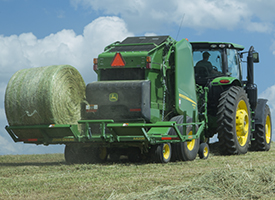
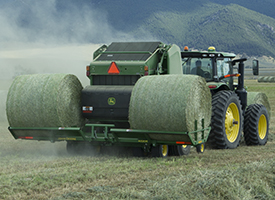
Because the accumulator is integrated into the frame of the baler, the baler's current maneuverability is maintained. Current solutions in the market are towed behind the baler, making it very difficult to back up or make tight corners around the farm. Tow-behind solutions require a more proficient tractor operator and more looking back at the baler and accumulator.
The integrated design of the Plus2 increases productivity for producers who bale on hills. This allows for bales to be ejected on any landscape, saving baling time in hilly conditions where operators have to travel or jockey the baler to drop bales. This will minimize or eliminate losing bales down hills.
Finally, the Plus2 provides the operator with an easy line of sight to see how many bales are on the cart. Visibility to the cart is easily accomplished by looking in the mirrors. There is no required additional expense for another monitor or camera (camera system is available as aftermarket kit).
Bale sensing and gate position system
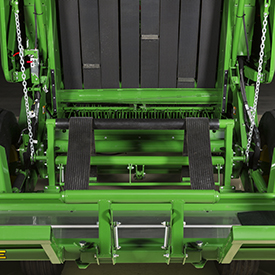
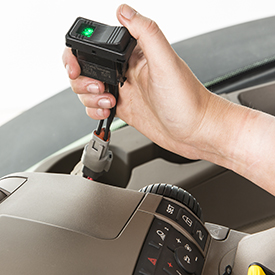
The bale sensing switch is in a position to detect the bale once it has exited the bale chamber. This assures proper transfer from baler to cart. Since the transfer arm is directly connected to the gate via chains, allowing the gate to open fully with a bale in an incorrect position could result in a bale getting stuck in front of the transfer arm. If there is no bale in the chamber and the gate is opened, the gate will only open to approximately 40 degrees.
The wiring harness for the Plus2 has an override switch located in the cab of the tractor that is used when the gate needs to be opened for servicing the baler or accumulator, when the bale chamber is empty. Once that switch is activated, the gate can be opened to the full height and it will not disrupt the sequence of the slider.
Alternating hydraulic slide
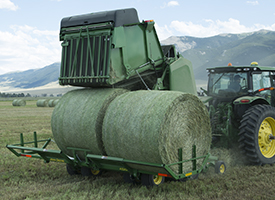

Running a 7, 8, 9, or 0 Series Baler with a Plus2 Accumulator provides a very similar baling experience for the operator as it was prior to the accumulator thanks to the alternating hydraulic slide. Once the bale is wrapped, the gate is opened and the transfer arm moves the bale to the open position of the cart. When the bale is slid onto the cart, then the gate will close. The only time added to the overall cycle time is the sliding of the bale which takes approximately 2 seconds.
Damper arm
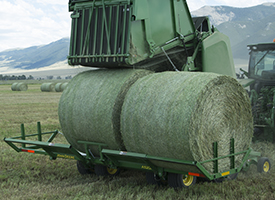

The bale damper arm, located on the rear of the cart, absorbs the energy of the bale as it is transferred. This feature keeps the bale on the cart at inclines up to 16 degrees. The bale damper can be swung open to gain better access for net loading and service. It is critical that the damper arm is reassembled properly after being opened. If the damper arm is not locked back into the operating position when baling resumes, it can be torn from the cart on the first dump.
Cart dump and variable dump speed
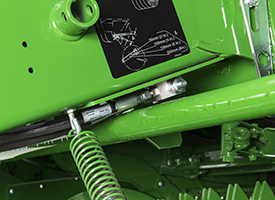 Adjustment valve
Adjustment valve
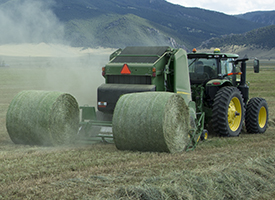 Accumulating bales
Accumulating bales
In order to maximize efficiency, the Plus2 Round Bale Accumulators are able to place or dump the bales from the cart while the tractor is moving. The third selective control valve (SCV) controls the dump functions of the cart. When actuated, the entire cart tilts, dumping all bales that it is carrying at that point.
This patented feature is able to get the rearward speed of the bale to match the ground speed of the tractor by adjusting a valve under the tongue. The end result is a bale that stops still in the field as the operator continue driving forward.
When dumping on the go, the speed at which the cart tilts affects how much the bale rolls when it hits the ground. Faster ground speed while baling requires a faster cart dump speed.
Telescoping wings
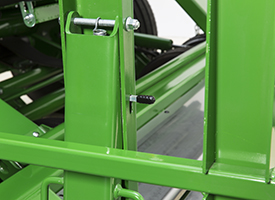
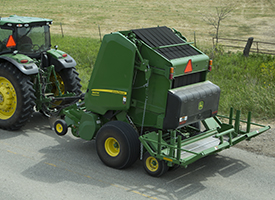
A spring-loaded latch keeps the wings in for transport and makes unlatching for field use easier.
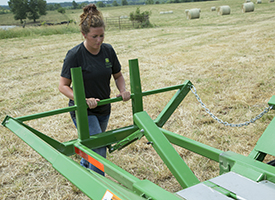
The wings need to be manually extended and retracted.
The wings on the Plus 2 need to be extended for field use and retracted for transport. In the transport configuration, the accumulator is no wider than the baler. This is important when transporting between fields, through narrow gates, or down the road.
Bale accumulation strategies
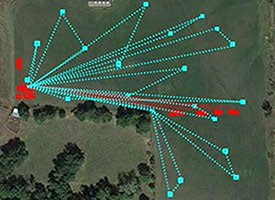 Bale accumulation pattern
Bale accumulation pattern
Red bales depict where the bales were placed with the Plus2 Round Bale accumulator. Blue bales depict where each of the bales were wrapped and would have been placed with a traditional non-accumulating baler.
- 5.3-ha (13-acre), L–shaped field
- 20 bales
- 74 percent reduction in distance traveled when removing bales from field by accumulating
- 60 percent reduction in time required to move bales to the stack yard
In today’s round baling operation, where the operator finishes wrapping the bale is where the bale is ejected. The John Deere Plus2 Round Bale Accumulator changes that.
The Plus2 Round Bale Accumulator allows the operator to carry up to two bales while making a third. This means that bales can be placed in the most strategic location to get them off of the field as quickly as possible while minimizing wheel traffic. Before producers begin baling with the Plus2 Accumulator, it is important to have a plan. The bales will no longer be randomly scattered. To maximize the Plus2, having predetermined accumulation sites will not only decrease bale removal times but will increase yields for future cuttings.
John Deere provides two very significant values to the producer who utilizes this machine.
The first value of accumulating bales is time reduction when getting the bales off of the field. In another factory-observed trial, an 8.1-ha (20-acre) field was baled with a traditional baler and balert with a Plus2 Accumulator attached. There were 25 bales made with the traditional baler and 26 with the accumulator. Distance traveled to move the bales to a central storage location in the field with the traditional baler was 4,013.6 m (13,168 ft). The accumulated bales only needed 704.1 m (2,310 ft) to get to the same location. That is more than an 80 percent reduction in total distance traveled using a loader tractor hauling two bales at a time.
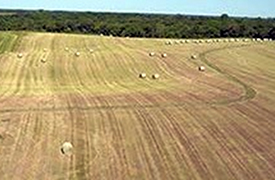
The second value of accumulating bales is the reduction in wheel traffic and the damage that excessive wheel traffic causes to regrowth. Round bales have the luxury of being able to stay in the field longer than square bales, and there are times when round bales sit in the fields longer than most producers like. Numerous university studies have proven that wheel traffic on regrowing alfalfa from the fifth day it was cut can cause a decrease in yields by 20 percent. The Plus2 Accumulator minimizes unnecessary wheel traffic by allowing the operator to reduce travel when getting the bales off of the field and into storage.
Plus2 also reduces operator fatigue. When baling in hilly conditions, there is no longer a need to leave the windrow and jack knife the baler to prevent the bale from rolling away. Operators can accumulate bales on the cart and dump at the predetermined, flat location. Growers do not have to worry about rolling bales through the fence or into the pond.

In areas where the fields are irrigated, the Plus2 allows the operator to get the bales off of the fields faster so the water can be turned back on sooner. It also reduces unnecessary trips across pivot wheel tracks, terraces, corn rows, and other field obstructions. Accumulating bales with the Plus2 reduces wear and tear on machines like bale stackers, self-loading wagons, and loader tractors.
Features
0 Series Round Balers - Model specification levels
Round baler models
| Previous 9 Series models |
New 0 Series models |
|
| 449 | → | 440E |
| 459E | → | 450E |
| 459 | → | 450M |
| 459 Silage Special | ||
| 469 | → | 460M |
| 469 Silage Special | ||
| 469 Premium | → | 460R |
| 559 | → | 550M |
| 559 Silage Special | ||
| 569 | → | 560M |
| 569 Silage Special | ||
| 569 Premium | → | 560R |
Round baler model specification
| Baler option | Applicable models |
E = Economy
|
440E and 450E |
M = Standard
|
450M, 460M, 550M*, and 560M |
R = Premium
|
460R and 560R |
*NOTE: The 550M Round Baler will only be available in dry hay and silage configurations.
0 Series Balers have implemented specification levels for all models in the baler lineup similar to what was done when the 459E was introduced. Pickup options will remain the same for the new models equivalent specification. The precutter pickups will have the same MegaWide™ Plus pickups that will be offered in mid specification (M) or the premium specifications (R) balers.
MegaWide™ High Capacity and Cutting (HC2) feeding system

The 0 Series Round Baler family welcomes the first, John Deere, North-American built precutter. This feed system in front of these machines is the MegaWide HC2. The MegaWide Plus name is known as the industry-leading feed system since its introduction with the 7 Series Balers. John Deere continues that legacy with the 0 Series. Proven designs of the MegaWide were maintained and improvements were made to key components to gain significant capacity.
Features of the MegaWide HC2
The MegaWide™ HC2 will only be available in a precutter configuration (available on the 450M, 460M, 460R, 560M, and 560R models):
- 1.22-m (4-ft) wide machines will have 14 knives
- 1.52-m (5-ft) wide machines will have 20 knives
The MegaWide HC2 has the same 2.2-m (7.22-ft) MegaWide Plus pickup from the 9 Series. Dry hay and silage 0 Series configurations will also have the MegaWide Plus pickup.


Before the introduction of the MegaWide HC2 , the cam-clutch protection for the driveline was only available on the 9 Series Premium Balers. It is in the base for the MegaWide HC2 precutter configurations. This driveline pushes the limitations of the baler and the MegaWide HC2 system by offering the best machine protection John Deere can provide.
Another feature brought over from the 9 Series Premium Balers and being offered on the 0 Series is the grease banks. All daily greasing can be done from the ground in one central location.
 MegaWide HC2 roller baffle and MegaWide Plus roller baffles
MegaWide HC2 roller baffle and MegaWide Plus roller baffles
The roller baffle on the MegaWide HC2 doubled in size from the MegaWide Plus from 10.2-cm (4-in.) to 20.3-cm (8-in.) diameter to allow for increased speeds and performance in larger windrows.


The 450M, 460M, 460R, 560M, and 560R Balers that can be configured with the MegaWide HC2 feed system will have the same flare-to-flare pickup width of 2.2 m (7.21 ft). This 2.2-m (7.21-ft), flare-to-flare, width on 1.22-m (4-ft) balers is only a feature of the MegaWide HC2 feed system.
 Primary rotor relationship to knives – front position
Primary rotor relationship to knives – front position
 Primary rotor from bale chamber
Primary rotor from bale chamber
The primary rotor is only available on the MegaWide HC2 and is located directly behind the MegaWide pickups.
- This rotor grabs the crop and drags it over the knives to size the crop to a theoretical length size of 66 mm (2.5 in.)
- For the 1.22-m (4-ft) machines, there are 14 slots to receive the knives that are located on the floor of the feed system
- The 1.52-m (5-ft) machine has 20 knives and 20 slots
 Fast-pitch augers on the primary rotor
Fast-pitch augers on the primary rotor
Industry-exclusive, fast-pitch augers have been placed on the primary rotor to move dry hay and silage past the transition points to avoid plugging.
 MegaWide HC2 secondary rotor from bale chamber
MegaWide HC2 secondary rotor from bale chamber
The secondary rotor is another component on the feed system that was re-designed from the MegaWide Plus feed system to handle the increased demands of the high-capacity system.
- The secondary rotor in the MegaWide HC2 is similar in location and design as the MegaWide Plus spiral rotor.
- The hex shaft on secondary rotor rotor on the MegaWide HC2 was increased from 3.2 cm (1.25 in.) from the MegaWide Plus to 3.8 cm (1.5 in.)
- The diameter of the tube was increased for additional strength and to prevent silage wrapping
- The number of tines was increased from two to three for additional capacity and flow of crop into the starter roll and chamber.

A third drive roll is another feature that will only be offered with the MegaWide HC2 feed system.
- Precutting crop releases additional moisture into the feed system of the baler so the MegaWide HC2 feed system added a third drive roll on the number 11 roller to ensure trouble-free bale formation even in the most difficult, high-moisture silage conditions.
- This feature is available only on the MegaWide HC2 feed system

All MegaWide HC2 feed systems will have silage components to limit maintenance and prevent crop build up on belts.
- Driven auger
- Starter roll scraper knife
- Auxiliary take up roller
- For precutter machines only - external belt guides
- External belt guides were designed to dramatically reduce amount of chaff in the gate
- Available through parts – retrofittable through 7 Series balers
Descriptive model numbering system
All 0 Series Balers use alpha-numeric identifiers for the model names:
The MegaWide HC2 can be ordered on mid specification (M) and premium specification (R) balers.
R specification balers will have the premium pickup with improved internal components that are covered under the 2-year/12,000-bale premium warranty
M specification balers and pickups will not contain premium baler components – exception for this is the MegaWide HC2 feed system will have the premium cam clutch for the driveline and grease banks.
For more information about the model specifications, see the chart below:
| Baler option | Applicable models |
E = Economy
|
440E and 450E |
M = Standard
|
450M, 460M, 550M*, and 560M |
R = Premium
|
460R and 560R |
*NOTE: The 550M is only available in dry hay and silage configurations.
New Holland, Roll-Belt, and CropCutter are trademarks of CNH Global N.V. and its subsidiaries.


Drop floor – if the baler exceeds capacity and plugs, the MegaWide HC2 can lower the knife floor from the cab of the tractor to easily feed the plug into the chamber.
- Drop floor is an insurance policy to allow the operator to push the machine knowing that a plug can clear in 30 seconds, not 30 minutes.
- In factory-observed testing with the 2016 test fleet, 99 percent of the plugs were cleared from the cab.
- Floor is self-cleaning – when lowered to feed a plug, it allows chaff that has been built up around the knives to fall through into the windrow.
- This release of crop allows the feed system to stay cleaner
- Allows for easier engagement of the knives and servicing of the knives
- The floor is also responsible for engaging the knives
- Based on lack of success for re-engaging knives in competitive machines, John Deere made sure the MegaWide™ HC2 was built to meet the demands a Deere producer expects.
- Knife-engagement forces on the MegaWide™ HC2 are 10 times that of the New Holland™ Roll-Belt™ 460 CropCutter® Baler. It gives the producer the confidence that if the knives are engaged, they are all up and cutting.
- Once the knives are up, each knife has individual spring protection, limiting bent or broken knives.
- Hit a rock and the knife moves out of the way and automatically re-engages.
Increased torque – the MegaWide HC2 feed system required an additional drive configuration to power the primary rotor and to meet the capacity goals.
- The MegaWide HC2 feed system has a T gearbox where the MegaWide Plus has a 90 degree box.
- The MegaWide Plus system had a cut-out clutch that protected the spiral rotor and pickup.
- The MegaWide HC2 eliminated that clutch because the secondary rotor is more robust than the MegaWide Plus spiral rotor.
- This allowed the primary and secondary rotor to be driven directly from the driveline.
- Both components are still clutch protected from the main driveline cam clutch, but there is approximately 10 times more torque being put through the primary and secondary rotor than what is found on the MegaWide Plus spiral rotor.
- This exponential change in torque is the driving force of the capacity gains in the MegaWide HC2 feed system.
- MegaWide HC2 pickup is still clutched for extended pickup life. That clutch is now located on the left-hand side of the baler. MegaWide Plus pickup clutches are still located on the right-hand side of the baler.
MegaWide HC2 feed systems will not have the adjustable crank handle for the pickup.
- MegaWide Plus machines will continue to have this an option.
Automatic electric-tie option using BaleTrak™ Pro monitor allows for more productivity
Audible alarm
 BaleTrak Pro monitor-controller
BaleTrak Pro monitor-controller
The BaleTrak Pro monitor-controller is included with the automatic electric tie option and the Edge-to-Edge option on the 450E Baler. The monitor sounds an alarm for near-full, full, and oversized bales.
- Monitor beeps once to notify the operator to even-up the bale prior to reaching the desired size.
- Monitor beeps twice when the bale reaches the desired size.
- If the operator continues to feed hay into the baler, the monitor will sound continuously to warn of an oversized bale.
- Bale shape bars are not available on the 440E or 450E Round Balers. The 440E and 450E Round Balers allow for adjustment of twine settings from the cab by using the BaleTrak Pro Monitor.
- The number of wraps on the Edge-to-Edge net wrap option on the 450E can be set with the BaleTrak Pro.
The audible level of the monitor can be adjusted.
Adjustable hitch to match wide array of tractor drawbar heights
 Side view of adjustable hitch
Side view of adjustable hitch
 Front view of adjustable hitch
Front view of adjustable hitch
The 9 Series Round Balers came standard with an adjustable hitch and this feature will continue to be in base with the 0 Series Round Balers. This feature allows the hitch height to be adjusted to optimize crop-feeding performance. Due to the wide array of tractor tire sizes and drawbar heights, hitch adjustment may be necessary to get the proper feed opening of the baler. The adjustable hitch eliminates the need for the 51-mm (2-in.) thick tractor drawbar kit (AE57344) because it has a wider opening.
Benefits of the adjustable hitch:
- Ability to match baler to numerous tire sizes
- Allows for drawbar height to fall within 330 mm to 559 mm (13 in. to 22 in.) from the top of the drawbar to the ground
- Eliminates narrow feed opening on the baler which can cause plugging
- Allows pickup head to follow terrain without missing crop
All eight bolts must be used when adjusting the hitch. There are four different positions as shown below:
 Position 1 (top) - regular and MegaTooth™ pickups
Position 1 (top) - regular and MegaTooth™ pickups
 Position 2
Position 2
 Position 3 (factory setting) - MegaWide Plus and MegaWide HC2
Position 3 (factory setting) - MegaWide Plus and MegaWide HC2
 Position 4 (bottom)
Position 4 (bottom)
Also standard on all 0 Series Round Balers, except the 450E, is the drawbar flap. This helps to eliminate hay from getting caught on the hitch of the baler. The drawbar flap is designed to allow the operator to remove or attach the flap without having to unhook the baler from the tractor.
 Drawbar flap
Drawbar flap
 Drawbar flap installed on baler
Drawbar flap installed on baler
MegaWide™ Plus pickup with MegaTough™ pickup teeth offers super capacity
 460M MegaWide Plus pickup
460M MegaWide Plus pickup
A MegaWide Plus pickup is available on 440E, 450M, 550M, and 560M Round Balers. It is base equipment on the 450M Silage, 550M Silage, 460M, 460M Silage, and 560M Silage Balers. The MegaWide Plus pickup is also incorporated into the new MegaWide High Capacity and Cutting (HC2) high-capacity precutter feed system.
0 Series Balers have implemented specification levels for all models in the baler lineup, similar to what was done when the 459E was introduced. Pickup options will remain the same for the new models equivalent specification. The precutter pickups will have the same MegaWide Plus pickups that will be offered in mid specification (M) or the premium specification (R) balers.
MegaWide Plus pickups make baling easier, especially in wide or windblown windrows, and increases productivity; more hay volume means more bales per hour.
- Flare-to-flare width of 1.8 m (5.9 ft) on balers with a 1.2 m (4-ft) wide bale chamber
- Flare-to-flare width of 2.2 m (7.2 ft) on balers with a 1.5-m (5-ft) wide bale chamber
- MegaWide Plus pickup makes it easier to produce better-shaped bales and improves crop pickup in wide, windblown, or scattered windrows
- Mega teeth, located at the ends of the pickup, pull crop around the flares when baling wide or windblown windrows
- MegaTough pickup teeth provide greater strength and durability
- Exclusive square design handles high-impact loads without yielding
- Sturdy toothbar design
- Self-adjusting roller baffle
- Spiral rotor-feed system improves feeding in all crop conditions
- Chain driven for positive feeding
- Cut-out clutch protected
- Semi-pneumatic gauge wheels
 MegaTough pickup teeth
MegaTough pickup teeth
Mega and MegaTough pickup teeth are base equipment:
- Mega teeth, at the ends of the pickup, are heavy-duty for long life and improved crop retrieval
- MegaTough pickup teeth are designed to withstand the harshest baling conditions and provide long service life
 Toothbars on 1.5-m (5-ft) baler
Toothbars on 1.5-m (5-ft) baler
The 1.2-m (4-ft) balers use a full-length, reinforced toothbar design.
The 1.5-m (5-ft) balers use a heavy, C-channel construction. The pickup toothbars are divided into two half-sections that mount to a center spider for increased strength and even crop feeding.
 Roller baffle
Roller baffle
Available only on the MegaWide Plus pickup, the patented roller baffle is self-adjusting and produces smoother crop flow across the pickup. The roller also improves crop pickup in small windrows and prevents roll ahead of crop.
When combined with the MegaWide Plus pickup, this feeding system allows increased ground speed with less chance of plugging for increased productivity in all field conditions.
- Self-adjusting
- Smooths crop for even flow across pickup
- Allows for faster ground speed with less chance of plugging
- Increases operator productivity
 Spiral rotor
Spiral rotor
 Auger and rotor feed system
Auger and rotor feed system
The MegaWide Plus pickup uses a rotor-feeding assembly, which mounts behind the pickup for smooth and even crop flow into the bale chamber.
- Augers and rotor teeth are driven on the same shaft, eliminating the need for additional drives.
- The rotor is fixed to the baler frame, allowing positive and even feeding into the bale chamber.
- Large-diameter converging augers have high crop-flow capacity, and auger scrolls help to force crop into the chamber.
- Spiral design enhances feeding in uneven windrows and reduces loading on the rotor.
 Rotor stripper
Rotor stripper
Rotor strippers allow crop to be lifted from the rotor teeth into the chamber without cutting or wrapping the crop.
 Cut-out clutch protection and feeder-drive chain
Cut-out clutch protection and feeder-drive chain
The MegaWide Plus pickups and spiral rotor are chain-driven for positive bale starts with cutout clutch protection. The pickup is being driven off the drive roll and bypasses the starter roll. This will allow for reduced wear and breakage of the starter roll chain.
 Semi-pneumatic gauge wheel
Semi-pneumatic gauge wheel
Semi-pneumatic gauge wheels provide smooth ground gauging over uneven terrain and protection to the pickup.
- Stiffer rubber sidewalls
- No air pressure to maintain, which mean no flat tires
- Adjustable to meet pickup tooth-to-stubble height requirements
The pickup float springs are positioned for excellent flotation.
- Adjustable to meet varying field conditions
- Float springs only support the pickup reel
- Rotor assembly is fixed to the baler frame, eliminating additional weight on the pickup system
 Adjustable crank handle
Adjustable crank handle
The adjusting crank positions the pickup to the desired operating height to match crop or field conditions.
An optional hydraulic pickup lift cylinder is available as an attachment.
- Makes raising for transport or clearing obstructions easy
- Crank handle serves as a down stop
- Adapts to regular, MegaTooth and MegaWide Plus pickups
- Hydraulic pickup lift comes standard on premium machines
Regular pickup offers large feed opening and low-profile, mid-mounted pickup
 Regular pickup on 450E Baler with converging wheels
Regular pickup on 450E Baler with converging wheels
Mounted in front of the baler wheels and directly below the bale chamber, the pickup hugs the ground for clean crop retrieval. Hay movement is minimized.
- V-belt driven
- 440E, 450E, and 450M Baler pickups are 116.6 cm (45.9 in.) wide
- 550M and 560M Baler pickups are 156 cm (61.4 in.) wide
- Large reel shaft and reel bearing
The small-diameter, low-profile pickup allows for good ground gauging and clean crop retrieval.
- Handles large, heavy windrows of hay and high-moisture crops
- Feeds hay directly to the forming chamber to reduce crop loss
- Low-profile pickup minimizes hay lift to reduce chaffing and retain hay quality
Side flares prevent hay from blowing off of the pickup ends, which reduces hay loss.
The closely-spaced pickup teeth extend to the baler side sheets to help build straight-edged bales.
Standard on regular pickups, compressor rods are contoured to control hay over the pickup radius for positive feeding. The compressor rack can be adjusted upward or downward to match the volume of material in the windrow and can be easily removed to match crop conditions.
 Adjustable crank handle
Adjustable crank handle
The adjusting crank positions the pickup to the desired operating height to match crop or field conditions.
An optional hydraulic pickup lift cylinder is available as an attachment.
- Makes raising for transport or clearing obstructions easy
- Crank handle serves as a down stop
- Adapts to regular and MegaWide™ Plus pickups
- Hydraulic pickup lift comes standard on premium machines
NOTE: Crank is not an option for the MegaWide High Capacity and Cutting (HC2) feed system.
Vertical forming chamber maintains uniform bale density
 Bale-starting diagram
Bale-starting diagram
As the hay enters the forming chamber from the pickup, belts immediately turn the hay to form a tight, dense core.
Incoming hay then feeds between the bale and the lower gate roll. Hay is tightly compressed into smooth, dense layers as it enters the bale.
Chaffing is greatly reduced to prevent loss and retain hay quality in the bale.
 Full-sized bale in bale chamber
Full-sized bale in bale chamber
The idler arm rises with bale growth, forcing oil from the hydraulic cylinder through a pressure-relief valve to maintain uniform bale density throughout the bale-forming process.
Exclusive DiamondTough™ belts with plate-type splices
 Staggered belts
Staggered belts
John Deere's 178-mm (7-in.) wide diamond-tread design ensures fast bale starts and grips the bale to prevent slippage and reduce chaffing. The treads are self-cleaning to reduce carryover. The belts are staggered to reduce the loss of fine material and are closely spaced to contain the hay for fast, easy starts.
The belts enclose 91 percent of the bale width to reduce loss of fine material and retain hay quality.
The staggered belt roll design enables any loose hay under or behind the belts to be returned to the pickup and into the baler. This design helps to prevent buildup at the front of the baler, which could cause hay loss and belt or splice damage.
 DiamondTough triple-weave belts
DiamondTough triple-weave belts

Every baler in the 0 Series Family uses DiamondTough belts. Belts are constructed using a patented triple-weave process of nylon and polyester materials.
They have the strength to handle heavy shock loads and help maintain consistent belt length.
The DiamondTough belts are more puncture and tear resistant than other belts on the market and provide improved belt life and reliability.
Plate-type fasteners
 Plate-type splices
Plate-type splices

All of the 0 Series Balers use the plate-type fasteners.
This closed-loop design uses a plate fastener with pre-assembled rivets that lock the fasteners into the belt, providing a powerful vice-type grip on the belt.
- The plates and rivets are manufactured from high-tensile stainless steel.
- Strong belt splices mean less maintenance and more productivity.
- The loop area is cold forged, making it extremely wear resistant in the coupling area, resulting in a very long cycle life.
- The spring steel pin is notched and locks into the splice connection without having to bend the pin or use external retainers.
Bale size adjustments can be made manually or automatically
 Manual bale size adjustment
Manual bale size adjustment
On the 440E Round Baler with hydraulic double-twine option, the near-full bale size warning can be adjusted by moving the nut (1) in the slot to match harvest requirements.
 BaleTrak Pro bale size adjustment
BaleTrak Pro bale size adjustment
 MegaWide™ High Capacity and Cutting (HC2) system monitor
MegaWide™ High Capacity and Cutting (HC2) system monitor
The bale size on 450M, 450E with automatic electric tie, 550M, 460M, and 560M Round Balers can be adjusted from the operator's station with the BaleTrak™ Pro monitor-controller by pressing symbol 2, then pushing the +/- symbol.
Features
Vertical forming chamber maintains uniform bale density
 Bale-starting diagram
Bale-starting diagram
As the hay enters the forming chamber from the pickup, belts immediately turn the hay to form a tight, dense core.
Incoming hay then feeds between the bale and the lower gate roll. Hay is tightly compressed into smooth, dense layers as it enters the bale.
Chaffing is greatly reduced to prevent loss and retain hay quality in the bale.
 Full-sized bale in bale chamber
Full-sized bale in bale chamber
The idler arm rises with bale growth, forcing oil from the hydraulic cylinder through a pressure-relief valve to maintain uniform bale density throughout the bale-forming process.
MegaWide™ High Capacity and Cutting (HC2) feeding system

The 0 Series Round Baler family welcomes the first, John Deere, North-American built precutter. This feed system in front of these machines is the MegaWide HC2. The MegaWide Plus name is known as the industry-leading feed system since its introduction with the 7 Series Balers. John Deere continues that legacy with the 0 Series. Proven designs of the MegaWide were maintained and improvements were made to key components to gain significant capacity.
Features of the MegaWide HC2
The MegaWide™ HC2 will only be available in a precutter configuration (available on the 450M, 460M, 460R, 560M, and 560R models):
- 1.22-m (4-ft) wide machines will have 14 knives
- 1.52-m (5-ft) wide machines will have 20 knives
The MegaWide HC2 has the same 2.2-m (7.22-ft) MegaWide Plus pickup from the 9 Series. Dry hay and silage 0 Series configurations will also have the MegaWide Plus pickup.


Before the introduction of the MegaWide HC2 , the cam-clutch protection for the driveline was only available on the 9 Series Premium Balers. It is in the base for the MegaWide HC2 precutter configurations. This driveline pushes the limitations of the baler and the MegaWide HC2 system by offering the best machine protection John Deere can provide.
Another feature brought over from the 9 Series Premium Balers and being offered on the 0 Series is the grease banks. All daily greasing can be done from the ground in one central location.
 MegaWide HC2 roller baffle and MegaWide Plus roller baffles
MegaWide HC2 roller baffle and MegaWide Plus roller baffles
The roller baffle on the MegaWide HC2 doubled in size from the MegaWide Plus from 10.2-cm (4-in.) to 20.3-cm (8-in.) diameter to allow for increased speeds and performance in larger windrows.


The 450M, 460M, 460R, 560M, and 560R Balers that can be configured with the MegaWide HC2 feed system will have the same flare-to-flare pickup width of 2.2 m (7.21 ft). This 2.2-m (7.21-ft), flare-to-flare, width on 1.22-m (4-ft) balers is only a feature of the MegaWide HC2 feed system.
 Primary rotor relationship to knives – front position
Primary rotor relationship to knives – front position
 Primary rotor from bale chamber
Primary rotor from bale chamber
The primary rotor is only available on the MegaWide HC2 and is located directly behind the MegaWide pickups.
- This rotor grabs the crop and drags it over the knives to size the crop to a theoretical length size of 66 mm (2.5 in.)
- For the 1.22-m (4-ft) machines, there are 14 slots to receive the knives that are located on the floor of the feed system
- The 1.52-m (5-ft) machine has 20 knives and 20 slots
 Fast-pitch augers on the primary rotor
Fast-pitch augers on the primary rotor
Industry-exclusive, fast-pitch augers have been placed on the primary rotor to move dry hay and silage past the transition points to avoid plugging.
 MegaWide HC2 secondary rotor from bale chamber
MegaWide HC2 secondary rotor from bale chamber
The secondary rotor is another component on the feed system that was re-designed from the MegaWide Plus feed system to handle the increased demands of the high-capacity system.
- The secondary rotor in the MegaWide HC2 is similar in location and design as the MegaWide Plus spiral rotor.
- The hex shaft on secondary rotor rotor on the MegaWide HC2 was increased from 3.2 cm (1.25 in.) from the MegaWide Plus to 3.8 cm (1.5 in.)
- The diameter of the tube was increased for additional strength and to prevent silage wrapping
- The number of tines was increased from two to three for additional capacity and flow of crop into the starter roll and chamber.

A third drive roll is another feature that will only be offered with the MegaWide HC2 feed system.
- Precutting crop releases additional moisture into the feed system of the baler so the MegaWide HC2 feed system added a third drive roll on the number 11 roller to ensure trouble-free bale formation even in the most difficult, high-moisture silage conditions.
- This feature is available only on the MegaWide HC2 feed system


Drop floor – if the baler exceeds capacity and plugs, the MegaWide HC2 can lower the knife floor from the cab of the tractor to easily feed the plug into the chamber.
- Drop floor is an insurance policy to allow the operator to push the machine knowing that a plug can clear in 30 seconds, not 30 minutes.
- In factory-observed testing with the 2016 test fleet, 99 percent of the plugs were cleared from the cab.
- Floor is self-cleaning – when lowered to feed a plug, it allows chaff that has been built up around the knives to fall through into the windrow.
- This release of crop allows the feed system to stay cleaner
- Allows for easier engagement of the knives and servicing of the knives
- The floor is also responsible for engaging the knives
- Based on lack of success for re-engaging knives in competitive machines, John Deere made sure the MegaWide™ HC2 was built to meet the demands a Deere producer expects.
- Knife-engagement forces on the MegaWide™ HC2 are 10 times that of the New Holland™ Roll-Belt™ 460 CropCutter® Baler. It gives the producer the confidence that if the knives are engaged, they are all up and cutting.
- Once the knives are up, each knife has individual spring protection, limiting bent or broken knives.
- Hit a rock and the knife moves out of the way and automatically re-engages.

All MegaWide HC2 feed systems will have silage components to limit maintenance and prevent crop build up on belts.
- Driven auger
- Starter roll scraper knife
- Auxiliary take up roller
- For precutter machines only - external belt guides
- External belt guides were designed to dramatically reduce amount of chaff in the gate
- Available through parts – retrofittable through 7 Series balers
Descriptive model numbering system
All 0 Series Balers use alpha-numeric identifiers for the model names:
The MegaWide HC2 can be ordered on mid specification (M) and premium specification (R) balers.
R specification balers will have the premium pickup with improved internal components that are covered under the 2-year/12,000-bale premium warranty
M specification balers and pickups will not contain premium baler components – exception for this is the MegaWide HC2 feed system will have the premium cam clutch for the driveline and grease banks.
For more information about the model specifications, see the chart below:
| Baler option | Applicable models |
E = Economy
|
440E and 450E |
M = Standard
|
450M, 460M, 550M*, and 560M |
R = Premium
|
460R and 560R |
*NOTE: The 550M is only available in dry hay and silage configurations.
New Holland, Roll-Belt, and CropCutter are trademarks of CNH Global N.V. and its subsidiaries.
Increased torque – the MegaWide HC2 feed system required an additional drive configuration to power the primary rotor and to meet the capacity goals.
- The MegaWide HC2 feed system has a T gearbox where the MegaWide Plus has a 90 degree box.
- The MegaWide Plus system had a cut-out clutch that protected the spiral rotor and pickup.
- The MegaWide HC2 eliminated that clutch because the secondary rotor is more robust than the MegaWide Plus spiral rotor.
- This allowed the primary and secondary rotor to be driven directly from the driveline.
- Both components are still clutch protected from the main driveline cam clutch, but there is approximately 10 times more torque being put through the primary and secondary rotor than what is found on the MegaWide Plus spiral rotor.
- This exponential change in torque is the driving force of the capacity gains in the MegaWide HC2 feed system.
- MegaWide HC2 pickup is still clutched for extended pickup life. That clutch is now located on the left-hand side of the baler. MegaWide Plus pickup clutches are still located on the right-hand side of the baler.
MegaWide HC2 feed systems will not have the adjustable crank handle for the pickup.
- MegaWide Plus machines will continue to have this an option.
Exclusive DiamondTough™ belts with plate-type splices
 Staggered belts
Staggered belts
John Deere's 178-mm (7-in.) wide diamond-tread design ensures fast bale starts and grips the bale to prevent slippage and reduce chaffing. The treads are self-cleaning to reduce carryover. The belts are staggered to reduce the loss of fine material and are closely spaced to contain the hay for fast, easy starts.
The belts enclose 91 percent of the bale width to reduce loss of fine material and retain hay quality.
The staggered belt roll design enables any loose hay under or behind the belts to be returned to the pickup and into the baler. This design helps to prevent buildup at the front of the baler, which could cause hay loss and belt or splice damage.
 DiamondTough triple-weave belts
DiamondTough triple-weave belts

Every baler in the 0 Series Family uses DiamondTough belts. Belts are constructed using a patented triple-weave process of nylon and polyester materials.
They have the strength to handle heavy shock loads and help maintain consistent belt length.
The DiamondTough belts are more puncture and tear resistant than other belts on the market and provide improved belt life and reliability.
Plate-type fasteners
 Plate-type splices
Plate-type splices

All of the 0 Series Balers use the plate-type fasteners.
This closed-loop design uses a plate fastener with pre-assembled rivets that lock the fasteners into the belt, providing a powerful vice-type grip on the belt.
- The plates and rivets are manufactured from high-tensile stainless steel.
- Strong belt splices mean less maintenance and more productivity.
- The loop area is cold forged, making it extremely wear resistant in the coupling area, resulting in a very long cycle life.
- The spring steel pin is notched and locks into the splice connection without having to bend the pin or use external retainers.
0 Series Round Balers - Model specification levels
Round baler models
| Previous 9 Series models |
New 0 Series models |
|
| 449 | → | 440E |
| 459E | → | 450E |
| 459 | → | 450M |
| 459 Silage Special | ||
| 469 | → | 460M |
| 469 Silage Special | ||
| 469 Premium | → | 460R |
| 559 | → | 550M |
| 559 Silage Special | ||
| 569 | → | 560M |
| 569 Silage Special | ||
| 569 Premium | → | 560R |
Round baler model specification
| Baler option | Applicable models |
E = Economy
|
440E and 450E |
M = Standard
|
450M, 460M, 550M*, and 560M |
R = Premium
|
460R and 560R |
*NOTE: The 550M Round Baler will only be available in dry hay and silage configurations.
0 Series Balers have implemented specification levels for all models in the baler lineup similar to what was done when the 459E was introduced. Pickup options will remain the same for the new models equivalent specification. The precutter pickups will have the same MegaWide™ Plus pickups that will be offered in mid specification (M) or the premium specifications (R) balers.
Automatic electric-tie option using BaleTrak™ Pro monitor allows for more productivity
Audible alarm
 BaleTrak Pro monitor-controller
BaleTrak Pro monitor-controller
The BaleTrak Pro monitor-controller is included with the automatic electric tie option and the Edge-to-Edge option on the 450E Baler. The monitor sounds an alarm for near-full, full, and oversized bales.
- Monitor beeps once to notify the operator to even-up the bale prior to reaching the desired size.
- Monitor beeps twice when the bale reaches the desired size.
- If the operator continues to feed hay into the baler, the monitor will sound continuously to warn of an oversized bale.
- Bale shape bars are not available on the 440E or 450E Round Balers. The 440E and 450E Round Balers allow for adjustment of twine settings from the cab by using the BaleTrak Pro Monitor.
- The number of wraps on the Edge-to-Edge net wrap option on the 450E can be set with the BaleTrak Pro.
The audible level of the monitor can be adjusted.
Regular pickup offers large feed opening and low-profile, mid-mounted pickup
 Regular pickup on 450E Baler with converging wheels
Regular pickup on 450E Baler with converging wheels
Mounted in front of the baler wheels and directly below the bale chamber, the pickup hugs the ground for clean crop retrieval. Hay movement is minimized.
- V-belt driven
- 440E, 450E, and 450M Baler pickups are 116.6 cm (45.9 in.) wide
- 550M and 560M Baler pickups are 156 cm (61.4 in.) wide
- Large reel shaft and reel bearing
The small-diameter, low-profile pickup allows for good ground gauging and clean crop retrieval.
- Handles large, heavy windrows of hay and high-moisture crops
- Feeds hay directly to the forming chamber to reduce crop loss
- Low-profile pickup minimizes hay lift to reduce chaffing and retain hay quality
Side flares prevent hay from blowing off of the pickup ends, which reduces hay loss.
The closely-spaced pickup teeth extend to the baler side sheets to help build straight-edged bales.
Standard on regular pickups, compressor rods are contoured to control hay over the pickup radius for positive feeding. The compressor rack can be adjusted upward or downward to match the volume of material in the windrow and can be easily removed to match crop conditions.
 Adjustable crank handle
Adjustable crank handle
The adjusting crank positions the pickup to the desired operating height to match crop or field conditions.
An optional hydraulic pickup lift cylinder is available as an attachment.
- Makes raising for transport or clearing obstructions easy
- Crank handle serves as a down stop
- Adapts to regular and MegaWide™ Plus pickups
- Hydraulic pickup lift comes standard on premium machines
NOTE: Crank is not an option for the MegaWide High Capacity and Cutting (HC2) feed system.
Bale size adjustments can be made manually or automatically
 Manual bale size adjustment
Manual bale size adjustment
On the 440E Round Baler with hydraulic double-twine option, the near-full bale size warning can be adjusted by moving the nut (1) in the slot to match harvest requirements.
 BaleTrak Pro bale size adjustment
BaleTrak Pro bale size adjustment
 MegaWide™ High Capacity and Cutting (HC2) system monitor
MegaWide™ High Capacity and Cutting (HC2) system monitor
The bale size on 450M, 450E with automatic electric tie, 550M, 460M, and 560M Round Balers can be adjusted from the operator's station with the BaleTrak™ Pro monitor-controller by pressing symbol 2, then pushing the +/- symbol.
Adjustable hitch to match wide array of tractor drawbar heights
 Side view of adjustable hitch
Side view of adjustable hitch
 Front view of adjustable hitch
Front view of adjustable hitch
The 9 Series Round Balers came standard with an adjustable hitch and this feature will continue to be in base with the 0 Series Round Balers. This feature allows the hitch height to be adjusted to optimize crop-feeding performance. Due to the wide array of tractor tire sizes and drawbar heights, hitch adjustment may be necessary to get the proper feed opening of the baler. The adjustable hitch eliminates the need for the 51-mm (2-in.) thick tractor drawbar kit (AE57344) because it has a wider opening.
Benefits of the adjustable hitch:
- Ability to match baler to numerous tire sizes
- Allows for drawbar height to fall within 330 mm to 559 mm (13 in. to 22 in.) from the top of the drawbar to the ground
- Eliminates narrow feed opening on the baler which can cause plugging
- Allows pickup head to follow terrain without missing crop
All eight bolts must be used when adjusting the hitch. There are four different positions as shown below:
 Position 1 (top) - regular and MegaTooth™ pickups
Position 1 (top) - regular and MegaTooth™ pickups
 Position 2
Position 2
 Position 3 (factory setting) - MegaWide Plus and MegaWide HC2
Position 3 (factory setting) - MegaWide Plus and MegaWide HC2
 Position 4 (bottom)
Position 4 (bottom)
Also standard on all 0 Series Round Balers, except the 450E, is the drawbar flap. This helps to eliminate hay from getting caught on the hitch of the baler. The drawbar flap is designed to allow the operator to remove or attach the flap without having to unhook the baler from the tractor.
 Drawbar flap
Drawbar flap
 Drawbar flap installed on baler
Drawbar flap installed on baler
MegaWide™ Plus pickup with MegaTough™ pickup teeth offers super capacity
 460M MegaWide Plus pickup
460M MegaWide Plus pickup
A MegaWide Plus pickup is available on 440E, 450M, 550M, and 560M Round Balers. It is base equipment on the 450M Silage, 550M Silage, 460M, 460M Silage, and 560M Silage Balers. The MegaWide Plus pickup is also incorporated into the new MegaWide High Capacity and Cutting (HC2) high-capacity precutter feed system.
0 Series Balers have implemented specification levels for all models in the baler lineup, similar to what was done when the 459E was introduced. Pickup options will remain the same for the new models equivalent specification. The precutter pickups will have the same MegaWide Plus pickups that will be offered in mid specification (M) or the premium specification (R) balers.
MegaWide Plus pickups make baling easier, especially in wide or windblown windrows, and increases productivity; more hay volume means more bales per hour.
- Flare-to-flare width of 1.8 m (5.9 ft) on balers with a 1.2 m (4-ft) wide bale chamber
- Flare-to-flare width of 2.2 m (7.2 ft) on balers with a 1.5-m (5-ft) wide bale chamber
- MegaWide Plus pickup makes it easier to produce better-shaped bales and improves crop pickup in wide, windblown, or scattered windrows
- Mega teeth, located at the ends of the pickup, pull crop around the flares when baling wide or windblown windrows
- MegaTough pickup teeth provide greater strength and durability
- Exclusive square design handles high-impact loads without yielding
- Sturdy toothbar design
- Self-adjusting roller baffle
- Spiral rotor-feed system improves feeding in all crop conditions
- Chain driven for positive feeding
- Cut-out clutch protected
- Semi-pneumatic gauge wheels
 MegaTough pickup teeth
MegaTough pickup teeth
Mega and MegaTough pickup teeth are base equipment:
- Mega teeth, at the ends of the pickup, are heavy-duty for long life and improved crop retrieval
- MegaTough pickup teeth are designed to withstand the harshest baling conditions and provide long service life
 Toothbars on 1.5-m (5-ft) baler
Toothbars on 1.5-m (5-ft) baler
The 1.2-m (4-ft) balers use a full-length, reinforced toothbar design.
The 1.5-m (5-ft) balers use a heavy, C-channel construction. The pickup toothbars are divided into two half-sections that mount to a center spider for increased strength and even crop feeding.
 Roller baffle
Roller baffle
Available only on the MegaWide Plus pickup, the patented roller baffle is self-adjusting and produces smoother crop flow across the pickup. The roller also improves crop pickup in small windrows and prevents roll ahead of crop.
When combined with the MegaWide Plus pickup, this feeding system allows increased ground speed with less chance of plugging for increased productivity in all field conditions.
- Self-adjusting
- Smooths crop for even flow across pickup
- Allows for faster ground speed with less chance of plugging
- Increases operator productivity
 Spiral rotor
Spiral rotor
 Auger and rotor feed system
Auger and rotor feed system
The MegaWide Plus pickup uses a rotor-feeding assembly, which mounts behind the pickup for smooth and even crop flow into the bale chamber.
- Augers and rotor teeth are driven on the same shaft, eliminating the need for additional drives.
- The rotor is fixed to the baler frame, allowing positive and even feeding into the bale chamber.
- Large-diameter converging augers have high crop-flow capacity, and auger scrolls help to force crop into the chamber.
- Spiral design enhances feeding in uneven windrows and reduces loading on the rotor.
 Rotor stripper
Rotor stripper
Rotor strippers allow crop to be lifted from the rotor teeth into the chamber without cutting or wrapping the crop.
 Cut-out clutch protection and feeder-drive chain
Cut-out clutch protection and feeder-drive chain
The MegaWide Plus pickups and spiral rotor are chain-driven for positive bale starts with cutout clutch protection. The pickup is being driven off the drive roll and bypasses the starter roll. This will allow for reduced wear and breakage of the starter roll chain.
 Semi-pneumatic gauge wheel
Semi-pneumatic gauge wheel
Semi-pneumatic gauge wheels provide smooth ground gauging over uneven terrain and protection to the pickup.
- Stiffer rubber sidewalls
- No air pressure to maintain, which mean no flat tires
- Adjustable to meet pickup tooth-to-stubble height requirements
The pickup float springs are positioned for excellent flotation.
- Adjustable to meet varying field conditions
- Float springs only support the pickup reel
- Rotor assembly is fixed to the baler frame, eliminating additional weight on the pickup system
 Adjustable crank handle
Adjustable crank handle
The adjusting crank positions the pickup to the desired operating height to match crop or field conditions.
An optional hydraulic pickup lift cylinder is available as an attachment.
- Makes raising for transport or clearing obstructions easy
- Crank handle serves as a down stop
- Adapts to regular, MegaTooth and MegaWide Plus pickups
- Hydraulic pickup lift comes standard on premium machines
Features
Drawn or integral model available to meet a variety of applications
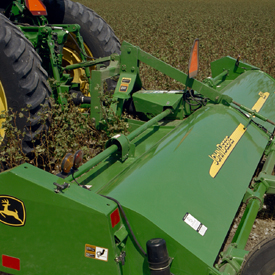 Hitch
Hitch
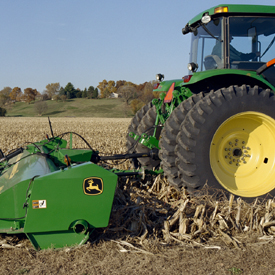 Drawn
Drawn
Square rotor designed for superior rotor strength
 Rotor
Rotor

Designed for superior rotor strength, the square rotor, together with the opposite-mounted flails, provides a machine with less potential vibration, increasing the life of rotor bearings and belts.
Since 248 knives are mounted on the full length of the rotors on the main cutterbar, with 2.5 cm (1 in.) of overlap, a stalk won't get missed. This is a significant improvement over the 216 knives mounted on the previous 220 Flail Shredder.
Rubber deflectors will not dent or rust
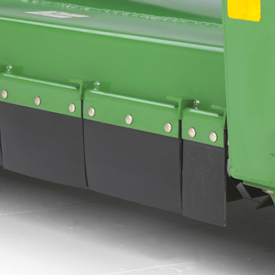 Rubber deflectors
Rubber deflectors

Flail fastening system eliminates clogging from mud or crop residue
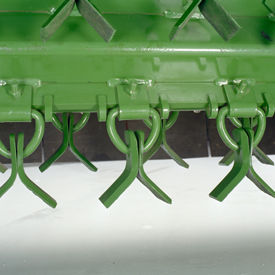 Flail fastening system
Flail fastening system

The flail fastening system eliminates clogging from mud or crop residue. Its bracket design also helps prevent knife and ring loss.
Heavy-duty John Deere-designed gearbox
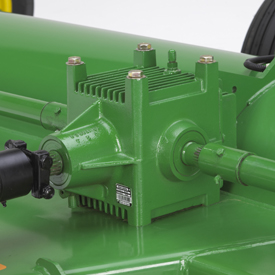 Gearbox
Gearbox
A heavy-duty, John Deere-designed and John Deere-built gearbox transfers power to the Kevlar® drive belts through cross shafts with intermediate bearing supports:
- The transmission is bolted directly to the frame.
- This gearbox has a constant-duty rating of 180 hp and a maximum rating of 270 hp.
- It carries a limited two-year warranty.
Kevlar is a U.S.-registered trademark of E.I. du Pont de Nemours and Company.
Steel rotor bearings for increased bearing life
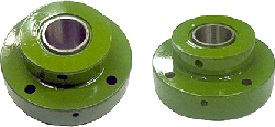 Rotor bearings
Rotor bearings
The rotor bearings are now made of steel and have a three-lip seal to keep the dirt out and increase the life of the bearings.
The side and center bearings now have guards in order to avoid leaks and dust, increasing the life of the bearings.
Optional wheel supports eliminate uncut middle strip in non-row-crop field
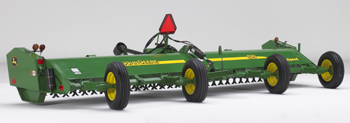 Wheel supports
Wheel supports

Optional wheel supports eliminate the uncut middle strip in crops like wheat, oats, and barley. The shredder can be pulled at an angle, offsetting the rotors and cutting evenly across the entire width of the machine.
Serviceability
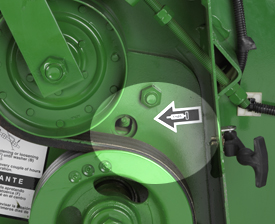 Lateral-bearing service access
Lateral-bearing service access
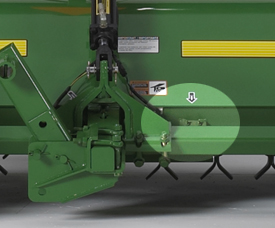 Center-bearing service access
Center-bearing service access
Hard-to-reach center bearings can be serviced with the conveniently located grease fittings at the rear of the machine:
- There is no need for the operator to crawl under the machine to perform this service task, thus increasing the probability of the job being performed and completed safely.
Features
Drawn tractor hookup
 Drawn tractor hookup
Drawn tractor hookup

Rubber deflectors will not dent or rust
 Rubber deflectors
Rubber deflectors

Heavy-duty John Deere-designed gearbox
 Gearbox
Gearbox
A heavy-duty gearbox transfers power to the power-band drive belts through cross shafts with intermediate bearing supports:
- Gearbox has a constant-duty rating of 150 hp and a maximum rating of 225 hp.
Steel rotor bearings for increased bearing life
 Rotor bearings
Rotor bearings
The rotor bearings are now made of steel and have a three-lip seal to keep the dirt out and increase the life of the bearings.
The side and center bearings now have guards in order to avoid leaks and dust, increasing the life of the bearings.
Features
Drawn tractor hookup
 Drawn tractor hookup
Drawn tractor hookup

Rubber deflectors will not dent or rust
 Rubber deflectors
Rubber deflectors

Heavy-duty John Deere-designed gearbox
 Gearbox
Gearbox
A heavy-duty gearbox transfers power to the power-band drive belts through cross shafts with intermediate bearing supports:
- Gearbox has a constant-duty rating of 150 hp and a maximum rating of 225 hp.
Steel rotor bearings for increased bearing life
 Rotor bearings
Rotor bearings
The rotor bearings are now made of steel and have a three-lip seal to keep the dirt out and increase the life of the bearings.
The side and center bearings now have guards in order to avoid leaks and dust, increasing the life of the bearings.
Features
Heavy-duty gearbox and drive shaft
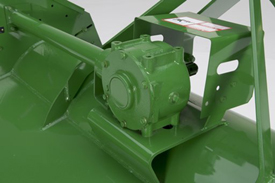 Heavy-duty gearbox
Heavy-duty gearbox
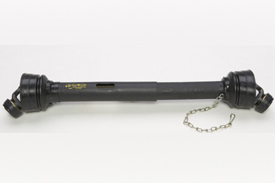 PTO drive shaft
PTO drive shaft
All John Deere flail mowers feature this rugged, heavy-duty gearbox with a continuous 65-hp rating and an intermittent 90-hp rating. Another feature included is a five-year, unlimited-hour warranty.
Base equipment side-slicer knives or optional smooth-cut knives available
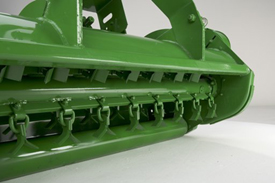 Side-slicer knives
Side-slicer knives
Base equipment side-slicer knives are good all-purpose knives. They provide aggressive cutting action in tough conditions.
The side-slicer knife characteristics are as follows:
- Knives are made of heat-treated alloy steel for durability.
- Individual knife weight, along with the centrifugal force created, provides an aggressive cutting action.
- Edges are ground to provide a sharp cutting surface and reduced horsepower requirements.
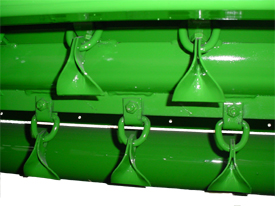 Rotor
Rotor
Smooth-cut knives can be ordered as an option:
- Smooth-cut knives utilize the same mountings as the side-slicer knives.
- These optional knives are good for grassy, weedy conditions and are self-cleaning.
- Knives can also be resharpened for added wear life.
Heavy-duty hood and end plates
 Heavy-duty hood and end plates
Heavy-duty hood and end plates
The hood and end plates are designed for heavy-duty applications:
- Hood is made of 0.48-cm (0.188-in.) thick steel to resist denting and wear.
- End plates are made of 0.64-cm (0.250-in.) thick steel to provide structural support and resistance to side thrusts.
- Full-length torque tube helps prevent twisting when operating on uneven ground.
Tractor hookup
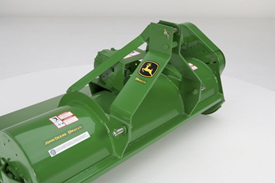 3-point hitch on 360 Flail Mower
3-point hitch on 360 Flail Mower
 3-point hitch on 370 and 390 Flail Mowers
3-point hitch on 370 and 390 Flail Mowers
All machines have a Category 2/1 3-point hitch. Bushings or reversible pins are included for Category 2/1 compatibility.
The 360, 370, and 390 Mowers with centrally mounted hitches are suited for normal cutting conditions:
- 360 Mower is compatible with quick-coupler Category 1 only.
-
370 and 390 Mowers are compatible with quick-coupler Category 1 and 2.
The 390 Mower with a 30.5-cm or 66-cm (12-in. or 26-in.) hitch offset to the right is ideal for trimming along walls, buildings, trees with low-lying branches, fences, or orchards.
Features
Heavy-duty gearbox and drive shaft
 Heavy-duty gearbox
Heavy-duty gearbox
 PTO drive shaft
PTO drive shaft
All John Deere flail mowers feature this rugged, heavy-duty gearbox with a continuous 65-hp rating and an intermittent 90-hp rating. Another feature included is a five-year, unlimited-hour warranty.
Base equipment side-slicer knives or optional smooth-cut knives available
 Side-slicer knives
Side-slicer knives
Base equipment side-slicer knives are good all-purpose knives. They provide aggressive cutting action in tough conditions.
The side-slicer knife characteristics are as follows:
- Knives are made of heat-treated alloy steel for durability.
- Individual knife weight, along with the centrifugal force created, provides an aggressive cutting action.
- Edges are ground to provide a sharp cutting surface and reduced horsepower requirements.
 Rotor
Rotor
Smooth-cut knives can be ordered as an option:
- Smooth-cut knives utilize the same mountings as the side-slicer knives.
- These optional knives are good for grassy, weedy conditions and are self-cleaning.
- Knives can also be resharpened for added wear life.
Heavy-duty hood and end plates
 Heavy-duty hood and end plates
Heavy-duty hood and end plates
The hood and end plates are designed for heavy-duty applications:
- Hood is made of 0.48-cm (0.188-in.) thick steel to resist denting and wear.
- End plates are made of 0.64-cm (0.250-in.) thick steel to provide structural support and resistance to side thrusts.
- Full-length torque tube helps prevent twisting when operating on uneven ground.
Tractor hookup
 3-point hitch on 360 Flail Mower
3-point hitch on 360 Flail Mower
 3-point hitch on 370 and 390 Flail Mowers
3-point hitch on 370 and 390 Flail Mowers
All machines have a Category 2/1 3-point hitch. Bushings or reversible pins are included for Category 2/1 compatibility.
The 360, 370, and 390 Mowers with centrally mounted hitches are suited for normal cutting conditions:
- 360 Mower is compatible with quick-coupler Category 1 only.
-
370 and 390 Mowers are compatible with quick-coupler Category 1 and 2.
The 390 Mower with a 30.5-cm or 66-cm (12-in. or 26-in.) hitch offset to the right is ideal for trimming along walls, buildings, trees with low-lying branches, fences, or orchards.
Features
Heavy-duty gearbox and drive shaft
 Heavy-duty gearbox
Heavy-duty gearbox
 PTO drive shaft
PTO drive shaft
All John Deere flail mowers feature this rugged, heavy-duty gearbox with a continuous 65-hp rating and an intermittent 90-hp rating. Another feature included is a five-year, unlimited-hour warranty.
Base equipment side-slicer knives or optional smooth-cut knives available
 Side-slicer knives
Side-slicer knives
Base equipment side-slicer knives are good all-purpose knives. They provide aggressive cutting action in tough conditions.
The side-slicer knife characteristics are as follows:
- Knives are made of heat-treated alloy steel for durability.
- Individual knife weight, along with the centrifugal force created, provides an aggressive cutting action.
- Edges are ground to provide a sharp cutting surface and reduced horsepower requirements.
 Rotor
Rotor
Smooth-cut knives can be ordered as an option:
- Smooth-cut knives utilize the same mountings as the side-slicer knives.
- These optional knives are good for grassy, weedy conditions and are self-cleaning.
- Knives can also be resharpened for added wear life.
Heavy-duty hood and end plates
 Heavy-duty hood and end plates
Heavy-duty hood and end plates
The hood and end plates are designed for heavy-duty applications:
- Hood is made of 0.48-cm (0.188-in.) thick steel to resist denting and wear.
- End plates are made of 0.64-cm (0.250-in.) thick steel to provide structural support and resistance to side thrusts.
- Full-length torque tube helps prevent twisting when operating on uneven ground.
Tractor hookup
 3-point hitch on 360 Flail Mower
3-point hitch on 360 Flail Mower
 3-point hitch on 370 and 390 Flail Mowers
3-point hitch on 370 and 390 Flail Mowers
All machines have a Category 2/1 3-point hitch. Bushings or reversible pins are included for Category 2/1 compatibility.
The 360, 370, and 390 Mowers with centrally mounted hitches are suited for normal cutting conditions:
- 360 Mower is compatible with quick-coupler Category 1 only.
-
370 and 390 Mowers are compatible with quick-coupler Category 1 and 2.
The 390 Mower with a 30.5-cm or 66-cm (12-in. or 26-in.) hitch offset to the right is ideal for trimming along walls, buildings, trees with low-lying branches, fences, or orchards.
Features
Adjustable cutting height
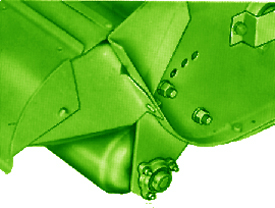 Roller
Roller

The roller can be set at four different cutting heights, from 1.3 cm to 12.7 cm (1/2 in. to 5 in.) The tractor's 3-point hitch upper link is used to regulate the cutting height between these positions.
Power take-off (PTO) drive shaft and gearbox
 Heavy-duty gearbox
Heavy-duty gearbox
 PTO drive shaft
PTO drive shaft
All mowers use a heavy-duty gearbox with a continuous rating of 65 hp.
The power is transmitted through fully shielded, telescoping drive shafts with quick-attach and detach characteristics for easy hookup.
36 flail-knife rotor provides uniform distribution of pulverized material
 Rotor and knives
Rotor and knives

A three-bank, counterbalanced rotor is equipped with 36 individually replaceable knives:
-
Rotor revolves at 1850 rpm to produce a 152.9-km/h (95-mph) blade-tip speed for a clean cut.
- Knives are arranged on the rotor to provide uniform distribution of material across the full cutting width.
- Knives pivot at their mounting points to minimize damage if an obstruction is hit.
Tractor hookup
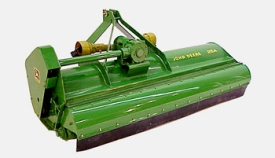 Tractor hookup
Tractor hookup

The 25A hitch is now compatible with any Category 1 3-point hitch (with or without the iMatch™ Quick-Coupler system).
iMatch compatibility starts with serial number 644700.
Features
Which rotary cutter is right?
John Deere rotary cutters lead the way with innovative design, superior performance, and proven durability. Valuable features are included such as the Double-Decker™ design and Max Flow cutting chamber, which prevent water and debris from accumulating on the smooth, dome-shaped top deck while the flat bottom deck absorbs the punishment from rocks and stumps.
The top deck stays smooth - no dents, no dings, no holes. The internal supports sandwiched between the top and bottom decks are key to the smooth and structure-free Max Flow cutting chamber, while at the same time provide added strength and durability.
To help promote safe operation, John Deere rotary cutters are equipped with front and rear safety-chain shields. John Deere rotary cutters continue to advance in value with larger, more powerful gearboxes, redesigned blade holders, and updated constant-velocity (CV) drivelines (special to the flex-wing models).
Here are situations when a rotary cutter is needed:
-
Clipping pastures encourages grass growth, optimizing on valuable pasture acreage.
-
Cutting grass and stalks helps control insects.
-
Routine cutting keeps weeds from reseeding.
-
It is the most cost efficient way to cut roadsides, parks, cemeteries, airport fields, hydro, gas, and telephone easements, and all other types of open properties.
-
Cutting grass waterways encourages root development and helps prevent erosion.
-
Knocking down stalks is essential in no-till and minimum-till fields.
-
Shredding stalks such as cotton, corn, and milo speeds up decomposition.
-
Clearing out brush is easy.
-
Use a rotary cutter to control undergrowth and grass in orchards, vineyards, and groves.
John Deere rotary cutters are available in three duty-level categories, three different spindle configurations, four hitch types, and three flex-wing sizes.
-
Mid-duty
-
MX models are available in 1.5-m (5-ft), 1.8-m (6-ft), 2.1-m (7-ft), 2.5-m (8-ft), 3.2-m (10-ft), and 4.6-m (15-ft) cut widths.
-
This duty-level category cuts brush up to 50.8 mm (2 in.) in diameter.
-
-
Heavy-duty
-
HX models are available in 3.2-m (10-ft), 4.2-m (14-ft), 4.6-m (15-ft), and 6.1-m (20-ft) cut widths.
-
HX6 is available in 1.8-m (6-ft) and the HX7 is available in 2.1-m (7-ft) cut widths; they cut brush up to 101.6 mm (4 in.) in diameter.
-
-
Commercial-duty
-
CX models are available in 3.2-m (10-ft), 4.6-m (15-ft), and 6.1-m (20 ft) cut widths; they cut brush 101.6 mm (4 in.) in diameter.
-
NOTE: CX models are heavier built to cut at a 101.6mm (4 in.) capacity level more frequently and for longer durations.
CX15 and CX20 product values
 CX15 and CX20 product values
CX15 and CX20 product values
100 percent factory assembled
- Category 5, multi-profile driveline
- Protected front chain shields
- Category 5, star-profile wing drivelines
- Smooth, dome-shaped Double-Decker™ design
- Spring-loaded wing arms
- Air bag and shock-absorber suspension
- Continuous, greaseable forged-wing hinges
- Cast hitch, best turn radius
- Hydraulic parking system
- Ball-and-clevis hitch connection
CX20 equipped with three deck rings
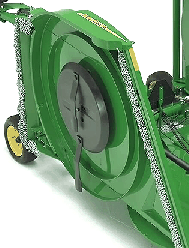 CX20 with three standard deck rings
CX20 with three standard deck rings

The CX20 is equipped with three deck rings, which are welded to the underside of the deck, just inside the outer circumference of blade travel. The deck rings help to limit the upward deflection of blades, when blades encounter immovable objects such as stumps and set-fast rocks.
Gearcases and blade holders provide better performance
 Gearcase and blade holder shown
Gearcase and blade holder shown
The John Deere gearboxes:
- Large seals
- Large housing
- Large output shaft
- Precision forged bevel gears
- Large bearings
- Stump jumper
Re-engineered gearcases and blade holders provide the following:
-
More horsepower
-
Faster blade-tip speed
-
Better performance
-
Quieter operation
-
Increased durability
Flex-wing constant-velocity (CV) driveline is easy to attach
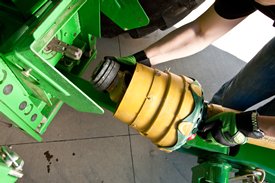 CV driveline
CV driveline

Benefits of the CV driveline:
-
Lock-slide collar, included on all John Deere’s drivelines, helps the attachment to the tractor using your hands on the driveline and not on the collar.
-
Professional seals on the cross kits allow for a lubrication interval up to 50 hours.
-
Grease zerks in the cap cross kits provide easy access for field lubrication.
-
Large, dimpled floating disks reduce wear and improve the grease retention.
-
Precision spherical ball-and-socket bearings distribute loading evenly and provide a long life and high performance.
A lightweight driveline with a lock-slide collar makes it fast and easy to attach.
Four larger, more durable gearcases
 Cross-section of gearcase
Cross-section of gearcase

The HX20 and CX20 Flex-Wing Rotary Cutters utilize a four-gearcase design. This is far superior to a three-gearcase design because the wing drivelines are able to operate at a range of angles, from 22 degrees down and up to 45 degrees. The wings fold up to 90 degrees for transport-lock purposes.
Additionally, the transfer of power from the tractor is dedicated to the transfer gearcase while the cutting is handled by three separate and properly sized individual gearcases. This results in superior drivetrain reliability and durability:
- HX20 uses a 250 continuous hp and 300 peak hp splitter gearcase, and 150 continuous hp and 205 peak hp center and outer gearcases.
- CX20 uses a 250 continuous hp and 300 peak hp splitter gearcase, and 150 continuous hp and 216 peak hp center and outer gearcases.
Large, tapered roller bearings and forged gears provide a long trouble-free operating life. Horizontal shafts in all gearcases are 1.5-cm (1-3/4 in.) in diameter to resist torque spikes. Output shafts have a tapered spline for a tight connection with blade holders.
Gearcases are backed up by a five-year warranty.
CX ground-control suspension
 Exclusive ground-control suspension
Exclusive ground-control suspension

CX Series Flex-Wing Rotary Cutters feature ground-control suspension, which is unique in the industry.
This suspension includes a heavy-duty axle with six wheels (five-wheel and three-wheel assemblies for the CX15 3.1-m [10-ft] model) and air springs with shock absorbers on all four-wheel assemblies.
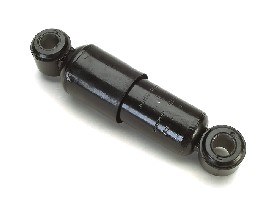 Shock absorbing
Shock absorbing

Shock absorbers provide a smooth ride for road travel and for hard and rough pastures, roadsides, etc. The shock-cushioning ability of the CX suspension is in a class by itself and contributes greatly to long, trouble-free operation of the machine.
Center-section air springs typically carry 90 psi of air pressure. Wing-section air springs typically carry 60 psi of air pressure.
All of the CX models are also available with springs and shock absorbers.
Continuous and greaseable wing-frame hinges
 HX20 hinges
HX20 hinges
 CX20 hinges
CX20 hinges
Center sections and wing sections are connected via 2.5-cm (1-in.) diameter continuous hinge pins. Hinge bushings are constructed of 15.2-cm (6-in.) long forged-steel segments and are greaseable to prevent hinge pins from seizing.
- The HX20 uses nine hinge bushing segments per side.
- The CX20 uses 16 hinge bushing segments per side, for a continuous hinge (front to back), providing superior resistance to the wear and tear caused by commercial usage.
Tight turns can be performed
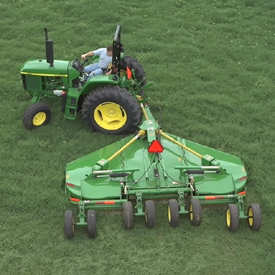 Tight turning radius (CX15 shown)
Tight turning radius (CX15 shown)

Hitches have a narrow profile and are 57.2 cm (22.5 in.) wide to allow a very tight turning radius, even when the tractor is equipped with dual wheels.
Transport lock offers a safe wing-up position
 Transport lock ensures wings stay secured
Transport lock ensures wings stay secured

A transport lock flips over the lift cylinder for backup to the hydraulics when transporting or servicing the cutter.
A wing lock is provided for additional safety during transporting or servicing. Additionally, the wing locks are spring-loaded so they can unfold against gravity on slopes up to five degrees.
Hydraulic height leveling system makes cutter leveling easy and safe
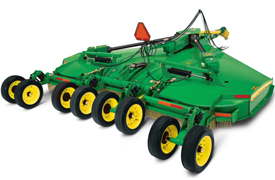 A manual-implement jack is in base equipment
A manual-implement jack is in base equipment

The HX15, CX15, HX20, and CX20 come standard with an industry-exclusive hydraulically-operated height leveling system with a swing-away parking stand that makes raising and lowering the cutter easy and safe. In addition, a manual-implement jack is in base equipment, so hitch leveling can also be adjusted without hydraulics. With this addition, the cutter will remain in the same position for long periods of time.
Five-year limited gearbox warranty provided on every John Deere rotary cutter
 Five-year warranty on all flex-wing gearboxes
Five-year warranty on all flex-wing gearboxes
 Five-year warranty on all rotary cutter gearboxes
Five-year warranty on all rotary cutter gearboxes
John Deere is so confident in the reliability of the gearbox, the warranty has been extended. John Deere rotary cutters come with a 5-year limited gearbox warranty.
Features
Which rotary cutter is right?
John Deere rotary cutters lead the way with innovative design, superior performance, and proven durability. Valuable features are included such as the Double-Decker™ design and Max Flow cutting chamber, which prevent water and debris from accumulating on the smooth, dome-shaped top deck while the flat bottom deck absorbs the punishment from rocks and stumps.
The top deck stays smooth - no dents, no dings, no holes. The internal supports sandwiched between the top and bottom decks are key to the smooth and structure-free Max Flow cutting chamber, while at the same time provide added strength and durability.
To help promote safe operation, John Deere rotary cutters are equipped with front and rear safety-chain shields. John Deere rotary cutters continue to advance in value with larger, more powerful gearboxes, redesigned blade holders, and updated constant-velocity (CV) drivelines (special to the flex-wing models).
Here are situations when a rotary cutter is needed:
-
Clipping pastures encourages grass growth, optimizing on valuable pasture acreage.
-
Cutting grass and stalks helps control insects.
-
Routine cutting keeps weeds from reseeding.
-
It is the most cost efficient way to cut roadsides, parks, cemeteries, airport fields, hydro, gas, and telephone easements, and all other types of open properties.
-
Cutting grass waterways encourages root development and helps prevent erosion.
-
Knocking down stalks is essential in no-till and minimum-till fields.
-
Shredding stalks such as cotton, corn, and milo speeds up decomposition.
-
Clearing out brush is easy.
-
Use a rotary cutter to control undergrowth and grass in orchards, vineyards, and groves.
John Deere rotary cutters are available in three duty-level categories, three different spindle configurations, four hitch types, and three flex-wing sizes.
-
Mid-duty
-
MX models are available in 1.5-m (5-ft), 1.8-m (6-ft), 2.1-m (7-ft), 2.5-m (8-ft), 3.2-m (10-ft), and 4.6-m (15-ft) cut widths.
-
This duty-level category cuts brush up to 50.8 mm (2 in.) in diameter.
-
-
Heavy-duty
-
HX models are available in 3.2-m (10-ft), 4.2-m (14-ft), 4.6-m (15-ft), and 6.1-m (20-ft) cut widths.
-
HX6 is available in 1.8-m (6-ft) and the HX7 is available in 2.1-m (7-ft) cut widths; they cut brush up to 101.6 mm (4 in.) in diameter.
-
-
Commercial-duty
-
CX models are available in 3.2-m (10-ft), 4.6-m (15-ft), and 6.1-m (20 ft) cut widths; they cut brush 101.6 mm (4 in.) in diameter.
-
NOTE: CX models are heavier built to cut at a 101.6mm (4 in.) capacity level more frequently and for longer durations.
Gearcases and blade holders provide better performance
 Gearcase and blade holder shown
Gearcase and blade holder shown
The John Deere gearboxes:
- Large seals
- Large housing
- Large output shaft
- Precision forged bevel gears
- Large bearings
- Stump jumper
Re-engineered gearcases and blade holders provide the following:
-
More horsepower
-
Faster blade-tip speed
-
Better performance
-
Quieter operation
-
Increased durability
Flex-wing constant-velocity (CV) driveline is easy to attach
 CV driveline
CV driveline

Benefits of the CV driveline:
-
Lock-slide collar, included on all John Deere’s drivelines, helps the attachment to the tractor using your hands on the driveline and not on the collar.
-
Professional seals on the cross kits allow for a lubrication interval up to 50 hours.
-
Grease zerks in the cap cross kits provide easy access for field lubrication.
-
Large, dimpled floating disks reduce wear and improve the grease retention.
-
Precision spherical ball-and-socket bearings distribute loading evenly and provide a long life and high performance.
A lightweight driveline with a lock-slide collar makes it fast and easy to attach.
Four larger, more durable gearcases
 Cross-section of gearcase
Cross-section of gearcase

The HX20 and CX20 Flex-Wing Rotary Cutters utilize a four-gearcase design. This is far superior to a three-gearcase design because the wing drivelines are able to operate at a range of angles, from 22 degrees down and up to 45 degrees. The wings fold up to 90 degrees for transport-lock purposes.
Additionally, the transfer of power from the tractor is dedicated to the transfer gearcase while the cutting is handled by three separate and properly sized individual gearcases. This results in superior drivetrain reliability and durability:
- HX20 uses a 250 continuous hp and 300 peak hp splitter gearcase, and 150 continuous hp and 205 peak hp center and outer gearcases.
- CX20 uses a 250 continuous hp and 300 peak hp splitter gearcase, and 150 continuous hp and 216 peak hp center and outer gearcases.
Large, tapered roller bearings and forged gears provide a long trouble-free operating life. Horizontal shafts in all gearcases are 1.5-cm (1-3/4 in.) in diameter to resist torque spikes. Output shafts have a tapered spline for a tight connection with blade holders.
Gearcases are backed up by a five-year warranty.
Heavy-duty axle with spring suspension
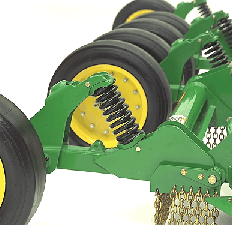 Spring suspension on all four-wheel assemblies
Spring suspension on all four-wheel assemblies

The HX Series Cutters feature a heavy-duty axle with six wheels and spring suspension on the four-wheel standards. Optional dual-wing wheels are available. A lower-priced four-wheel rigid axle version is also available.
Continuous and greaseable wing-frame hinges
 HX20 hinges
HX20 hinges
 CX20 hinges
CX20 hinges
Center sections and wing sections are connected via 2.5-cm (1-in.) diameter continuous hinge pins. Hinge bushings are constructed of 15.2-cm (6-in.) long forged-steel segments and are greaseable to prevent hinge pins from seizing.
- The HX20 uses nine hinge bushing segments per side.
- The CX20 uses 16 hinge bushing segments per side, for a continuous hinge (front to back), providing superior resistance to the wear and tear caused by commercial usage.
Tight turns can be performed
 Tight turning radius (CX15 shown)
Tight turning radius (CX15 shown)

Hitches have a narrow profile and are 57.2 cm (22.5 in.) wide to allow a very tight turning radius, even when the tractor is equipped with dual wheels.
Transport lock offers a safe wing-up position
 Transport lock ensures wings stay secured
Transport lock ensures wings stay secured

A transport lock flips over the lift cylinder for backup to the hydraulics when transporting or servicing the cutter.
A wing lock is provided for additional safety during transporting or servicing. Additionally, the wing locks are spring-loaded so they can unfold against gravity on slopes up to five degrees.
Hydraulic height leveling system makes cutter leveling easy and safe
 A manual-implement jack is in base equipment
A manual-implement jack is in base equipment

The HX15, CX15, HX20, and CX20 come standard with an industry-exclusive hydraulically-operated height leveling system with a swing-away parking stand that makes raising and lowering the cutter easy and safe. In addition, a manual-implement jack is in base equipment, so hitch leveling can also be adjusted without hydraulics. With this addition, the cutter will remain in the same position for long periods of time.
Five-year limited gearbox warranty provided on every John Deere rotary cutter
 Five-year warranty on all flex-wing gearboxes
Five-year warranty on all flex-wing gearboxes
 Five-year warranty on all rotary cutter gearboxes
Five-year warranty on all rotary cutter gearboxes
John Deere is so confident in the reliability of the gearbox, the warranty has been extended. John Deere rotary cutters come with a 5-year limited gearbox warranty.
Features
Which rotary cutter is right?
John Deere rotary cutters lead the way with innovative design, superior performance, and proven durability. Valuable features are included such as the Double-Decker™ design and Max Flow cutting chamber, which prevent water and debris from accumulating on the smooth, dome-shaped top deck while the flat bottom deck absorbs the punishment from rocks and stumps.
The top deck stays smooth - no dents, no dings, no holes. The internal supports sandwiched between the top and bottom decks are key to the smooth and structure-free Max Flow cutting chamber, while at the same time provide added strength and durability.
To help promote safe operation, John Deere rotary cutters are equipped with front and rear safety-chain shields. John Deere rotary cutters continue to advance in value with larger, more powerful gearboxes, redesigned blade holders, and updated constant-velocity (CV) drivelines (special to the flex-wing models).
Here are situations when a rotary cutter is needed:
-
Clipping pastures encourages grass growth, optimizing on valuable pasture acreage.
-
Cutting grass and stalks helps control insects.
-
Routine cutting keeps weeds from reseeding.
-
It is the most cost efficient way to cut roadsides, parks, cemeteries, airport fields, hydro, gas, and telephone easements, and all other types of open properties.
-
Cutting grass waterways encourages root development and helps prevent erosion.
-
Knocking down stalks is essential in no-till and minimum-till fields.
-
Shredding stalks such as cotton, corn, and milo speeds up decomposition.
-
Clearing out brush is easy.
-
Use a rotary cutter to control undergrowth and grass in orchards, vineyards, and groves.
John Deere rotary cutters are available in three duty-level categories, three different spindle configurations, four hitch types, and three flex-wing sizes.
-
Mid-duty
-
MX models are available in 1.5-m (5-ft), 1.8-m (6-ft), 2.1-m (7-ft), 2.5-m (8-ft), 3.2-m (10-ft), and 4.6-m (15-ft) cut widths.
-
This duty-level category cuts brush up to 50.8 mm (2 in.) in diameter.
-
-
Heavy-duty
-
HX models are available in 3.2-m (10-ft), 4.2-m (14-ft), 4.6-m (15-ft), and 6.1-m (20-ft) cut widths.
-
HX6 is available in 1.8-m (6-ft) and the HX7 is available in 2.1-m (7-ft) cut widths; they cut brush up to 101.6 mm (4 in.) in diameter.
-
-
Commercial-duty
-
CX models are available in 3.2-m (10-ft), 4.6-m (15-ft), and 6.1-m (20 ft) cut widths; they cut brush 101.6 mm (4 in.) in diameter.
-
NOTE: CX models are heavier built to cut at a 101.6mm (4 in.) capacity level more frequently and for longer durations.
CX15 and CX20 product values
 CX15 and CX20 product values
CX15 and CX20 product values
100 percent factory assembled
- Category 5, multi-profile driveline
- Protected front chain shields
- Category 5, star-profile wing drivelines
- Smooth, dome-shaped Double-Decker™ design
- Spring-loaded wing arms
- Air bag and shock-absorber suspension
- Continuous, greaseable forged-wing hinges
- Cast hitch, best turn radius
- Hydraulic parking system
- Ball-and-clevis hitch connection
CX15 equipped with three deck rings
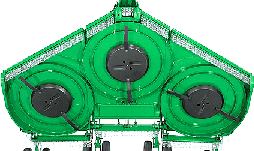 CX15 with three standard deck rings
CX15 with three standard deck rings

The CX15 is equipped with three deck rings, which are welded to the underside of the deck, just inside the outer circumference of blade travel. The deck rings help to limit the upward deflection of blades when the blades encounter immovable objects, such as stumps and set-fast rocks.
Gearcases and blade holders provide better performance
 Gearcase and blade holder shown
Gearcase and blade holder shown
The John Deere gearboxes:
- Large seals
- Large housing
- Large output shaft
- Precision forged bevel gears
- Large bearings
- Stump jumper
Re-engineered gearcases and blade holders provide the following:
-
More horsepower
-
Faster blade-tip speed
-
Better performance
-
Quieter operation
-
Increased durability
Flex-wing constant-velocity (CV) driveline is easy to attach
 CV driveline
CV driveline

Benefits of the CV driveline:
-
Lock-slide collar, included on all John Deere’s drivelines, helps the attachment to the tractor using your hands on the driveline and not on the collar.
-
Professional seals on the cross kits allow for a lubrication interval up to 50 hours.
-
Grease zerks in the cap cross kits provide easy access for field lubrication.
-
Large, dimpled floating disks reduce wear and improve the grease retention.
-
Precision spherical ball-and-socket bearings distribute loading evenly and provide a long life and high performance.
A lightweight driveline with a lock-slide collar makes it fast and easy to attach.
Serviceability
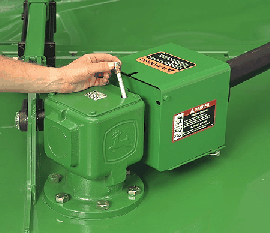 Gearcase with oil-level dipstick
Gearcase with oil-level dipstick

Gearcases are provided with oil-level dipsticks.
Spring-loaded check-valve vents are provided to release any air pressure that might build up within the gearcase and to keep the rotary cutter deck free of oil that would otherwise spew out of permanently open vents.
All pivoting points that would benefit from greasing are provided with grease zerks. Wing hinges in particular are provided with individual grease zerks. It is important to note that these points require greasing infrequently; lubrication is for protection against seizing, not wear.
CX ground-control suspension
 Exclusive ground-control suspension
Exclusive ground-control suspension

CX Series Flex-Wing Rotary Cutters feature ground-control suspension, which is unique in the industry.
This suspension includes a heavy-duty axle with six wheels (five-wheel and three-wheel assemblies for the CX15 3.1-m [10-ft] model) and air springs with shock absorbers on all four-wheel assemblies.
 Shock absorbing
Shock absorbing

Shock absorbers provide a smooth ride for road travel and for hard and rough pastures, roadsides, etc. The shock-cushioning ability of the CX suspension is in a class by itself and contributes greatly to long, trouble-free operation of the machine.
Center-section air springs typically carry 90 psi of air pressure. Wing-section air springs typically carry 60 psi of air pressure.
All of the CX models are also available with springs and shock absorbers.
Continuous and greaseable wing-frame hinges
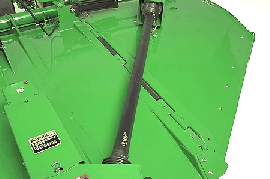 HX15 hinges
HX15 hinges
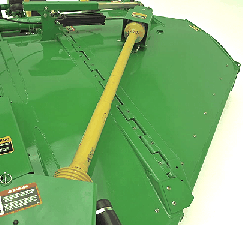 CX15 hinges
CX15 hinges
Center sections and wing sections are connected via 2.5-cm (1-in.) diameter continuous hinge pins. Hinge bushings are constructed of 15.2-cm (6-in.) long forged-steel segments and are greaseable to prevent hinge pins from seizing:
-
The HX15 uses eight hinge bushing segments per side.
-
The CX15 uses 12 hinge bushing segments per side, for a continuous hinge (front to back), providing superior resistance to the wear and tear caused by commercial usage.
Tight turns can be performed
 Tight turning radius (CX15 shown)
Tight turning radius (CX15 shown)

Hitches have a narrow profile and are 57.2 cm (22.5 in.) wide to allow a very tight turning radius, even when the tractor is equipped with dual wheels.
Transport lock offers a safe wing-up position
 Transport lock ensures wings stay secured
Transport lock ensures wings stay secured

A transport lock flips over the lift cylinder for backup to the hydraulics when transporting or servicing the cutter.
A wing lock is provided for additional safety during transporting or servicing. Additionally, the wing locks are spring-loaded so they can unfold against gravity on slopes up to five degrees.
Hydraulic height leveling system makes cutter leveling easy and safe
 A manual-implement jack is in base equipment
A manual-implement jack is in base equipment

The HX15, CX15, HX20, and CX20 come standard with an industry-exclusive hydraulically-operated height leveling system with a swing-away parking stand that makes raising and lowering the cutter easy and safe. In addition, a manual-implement jack is in base equipment, so hitch leveling can also be adjusted without hydraulics. With this addition, the cutter will remain in the same position for long periods of time.
3.1-m (10-ft) flex-wing weight box
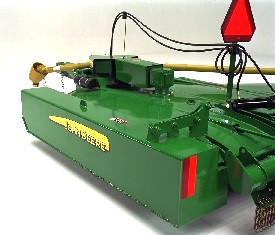 Weight box
Weight box
 Top view (extra dual spindles and wheels on the wing shown)
Top view (extra dual spindles and wheels on the wing shown)
The CX15 is available as a 3.1-m (10-ft) Flex-Wing Rotary Cutter with a 15.2-cm (6-in.) blade overlap by removing the left wing and adding a weight box.
-
The weight box hinges to the center deck and bolts to the anchor bracket in place of the left wing.
-
Weight box is shipped factory-filled with concrete.
Five-year limited gearbox warranty provided on every John Deere rotary cutter
 Five-year warranty on all flex-wing gearboxes
Five-year warranty on all flex-wing gearboxes
 Five-year warranty on all rotary cutter gearboxes
Five-year warranty on all rotary cutter gearboxes
John Deere is so confident in the reliability of the gearbox, the warranty has been extended. John Deere rotary cutters come with a 5-year limited gearbox warranty.
Features
Which rotary cutter is right?
John Deere rotary cutters lead the way with innovative design, superior performance, and proven durability. Valuable features are included such as the Double-Decker™ design and Max Flow cutting chamber, which prevent water and debris from accumulating on the smooth, dome-shaped top deck while the flat bottom deck absorbs the punishment from rocks and stumps.
The top deck stays smooth - no dents, no dings, no holes. The internal supports sandwiched between the top and bottom decks are key to the smooth and structure-free Max Flow cutting chamber, while at the same time provide added strength and durability.
To help promote safe operation, John Deere rotary cutters are equipped with front and rear safety-chain shields. John Deere rotary cutters continue to advance in value with larger, more powerful gearboxes, redesigned blade holders, and updated constant-velocity (CV) drivelines (special to the flex-wing models).
Here are situations when a rotary cutter is needed:
-
Clipping pastures encourages grass growth, optimizing on valuable pasture acreage.
-
Cutting grass and stalks helps control insects.
-
Routine cutting keeps weeds from reseeding.
-
It is the most cost efficient way to cut roadsides, parks, cemeteries, airport fields, hydro, gas, and telephone easements, and all other types of open properties.
-
Cutting grass waterways encourages root development and helps prevent erosion.
-
Knocking down stalks is essential in no-till and minimum-till fields.
-
Shredding stalks such as cotton, corn, and milo speeds up decomposition.
-
Clearing out brush is easy.
-
Use a rotary cutter to control undergrowth and grass in orchards, vineyards, and groves.
John Deere rotary cutters are available in three duty-level categories, three different spindle configurations, four hitch types, and three flex-wing sizes.
-
Mid-duty
-
MX models are available in 1.5-m (5-ft), 1.8-m (6-ft), 2.1-m (7-ft), 2.5-m (8-ft), 3.2-m (10-ft), and 4.6-m (15-ft) cut widths.
-
This duty-level category cuts brush up to 50.8 mm (2 in.) in diameter.
-
-
Heavy-duty
-
HX models are available in 3.2-m (10-ft), 4.2-m (14-ft), 4.6-m (15-ft), and 6.1-m (20-ft) cut widths.
-
HX6 is available in 1.8-m (6-ft) and the HX7 is available in 2.1-m (7-ft) cut widths; they cut brush up to 101.6 mm (4 in.) in diameter.
-
-
Commercial-duty
-
CX models are available in 3.2-m (10-ft), 4.6-m (15-ft), and 6.1-m (20 ft) cut widths; they cut brush 101.6 mm (4 in.) in diameter.
-
NOTE: CX models are heavier built to cut at a 101.6mm (4 in.) capacity level more frequently and for longer durations.
Gearcases and blade holders provide better performance
 Gearcase and blade holder shown
Gearcase and blade holder shown
The John Deere gearboxes:
- Large seals
- Large housing
- Large output shaft
- Precision forged bevel gears
- Large bearings
- Stump jumper
Re-engineered gearcases and blade holders provide the following:
-
More horsepower
-
Faster blade-tip speed
-
Better performance
-
Quieter operation
-
Increased durability
Flex-wing constant-velocity (CV) driveline is easy to attach
 CV driveline
CV driveline

Benefits of the CV driveline:
-
Lock-slide collar, included on all John Deere’s drivelines, helps the attachment to the tractor using your hands on the driveline and not on the collar.
-
Professional seals on the cross kits allow for a lubrication interval up to 50 hours.
-
Grease zerks in the cap cross kits provide easy access for field lubrication.
-
Large, dimpled floating disks reduce wear and improve the grease retention.
-
Precision spherical ball-and-socket bearings distribute loading evenly and provide a long life and high performance.
A lightweight driveline with a lock-slide collar makes it fast and easy to attach.
Four larger, more durable gearcases
 Cross-section of gearcase
Cross-section of gearcase

The HX15 and CX15 Flex-Wing Rotary Cutters utilize a four-gearcase design (with the exception of the 3.1-m [10-ft] CX15 weight-box model). This is far superior to a three-gearcase design because the wing drivelines are able to operate at a range of angles, from 22 degrees down and up to 45 degrees. The wings fold up to 90 degrees for transport-lock purposes.
Additionally, the transfer of power from the tractor is dedicated to the transfer gearcase while the cutting is handled by three separate and properly-sized individual gearcases. This results in superior drivetrain reliability and durability.
- HX15 uses a 250 continuous hp and 300 peak hp splitter gearcase, and 150 continuous hp and 205 peak hp center and outer gearcases.
- CX15 uses a 250 continuous hp and 300 peak hp splitter gearcase, and 150 continuous hp and 216 peak hp center and outer gearcases.
Large, tapered roller bearings and forged gears enable a long and trouble-free operating life. Horizontal shafts in all gearcases are 4.5 cm (1.75 in.) in diameter to resist torque spikes. Output shafts have a tapered spline for a tight connection with bladeholders.
Gearcases are backed up by a five-year warranty.
Heavy-duty axle with spring suspension
 Spring suspension on all four-wheel assemblies
Spring suspension on all four-wheel assemblies

The HX Series Cutters feature a heavy-duty axle with six wheels and spring suspension on the four-wheel standards. Optional dual-wing wheels are available. A lower-priced four-wheel rigid axle version is also available.
Tight turns can be performed
 Tight turning radius (CX15 shown)
Tight turning radius (CX15 shown)

Hitches have a narrow profile and are 57.2 cm (22.5 in.) wide to allow a very tight turning radius, even when the tractor is equipped with dual wheels.
Transport lock offers a safe wing-up position
 Transport lock ensures wings stay secured
Transport lock ensures wings stay secured

A transport lock flips over the lift cylinder for backup to the hydraulics when transporting or servicing the cutter.
A wing lock is provided for additional safety during transporting or servicing. Additionally, the wing locks are spring-loaded so they can unfold against gravity on slopes up to five degrees.
Serviceability
 Gearcase with oil-level dipstick
Gearcase with oil-level dipstick

Gearcases are provided with oil-level dipsticks.
Spring-loaded check-valve vents are provided to release any air pressure that might build up within the gearcase and to keep the rotary cutter deck free of oil that would otherwise spew out of permanently open vents.
All pivoting points that would benefit from greasing are provided with grease zerks. Wing hinges in particular are provided with individual grease zerks. It is important to note that these points require greasing infrequently; lubrication is for protection against seizing, not wear.
Hydraulic height leveling system makes cutter leveling easy and safe
 A manual-implement jack is in base equipment
A manual-implement jack is in base equipment

The HX15, CX15, HX20, and CX20 come standard with an industry-exclusive hydraulically-operated height leveling system with a swing-away parking stand that makes raising and lowering the cutter easy and safe. In addition, a manual-implement jack is in base equipment, so hitch leveling can also be adjusted without hydraulics. With this addition, the cutter will remain in the same position for long periods of time.
Five-year limited gearbox warranty provided on every John Deere rotary cutter
 Five-year warranty on all flex-wing gearboxes
Five-year warranty on all flex-wing gearboxes
 Five-year warranty on all rotary cutter gearboxes
Five-year warranty on all rotary cutter gearboxes
John Deere is so confident in the reliability of the gearbox, the warranty has been extended. John Deere rotary cutters come with a 5-year limited gearbox warranty.
Features
Which rotary cutter is right?
John Deere rotary cutters lead the way with innovative design, superior performance, and proven durability. Valuable features are included such as the Double-Decker™ design and Max Flow cutting chamber, which prevent water and debris from accumulating on the smooth, dome-shaped top deck while the flat bottom deck absorbs the punishment from rocks and stumps.
The top deck stays smooth - no dents, no dings, no holes. The internal supports sandwiched between the top and bottom decks are key to the smooth and structure-free Max Flow cutting chamber, while at the same time provide added strength and durability.
To help promote safe operation, John Deere rotary cutters are equipped with front and rear safety-chain shields. John Deere rotary cutters continue to advance in value with larger, more powerful gearboxes, redesigned blade holders, and updated constant-velocity (CV) drivelines (special to the flex-wing models).
Here are situations when a rotary cutter is needed:
-
Clipping pastures encourages grass growth, optimizing on valuable pasture acreage.
-
Cutting grass and stalks helps control insects.
-
Routine cutting keeps weeds from reseeding.
-
It is the most cost efficient way to cut roadsides, parks, cemeteries, airport fields, hydro, gas, and telephone easements, and all other types of open properties.
-
Cutting grass waterways encourages root development and helps prevent erosion.
-
Knocking down stalks is essential in no-till and minimum-till fields.
-
Shredding stalks such as cotton, corn, and milo speeds up decomposition.
-
Clearing out brush is easy.
-
Use a rotary cutter to control undergrowth and grass in orchards, vineyards, and groves.
John Deere rotary cutters are available in three duty-level categories, three different spindle configurations, four hitch types, and three flex-wing sizes.
-
Mid-duty
-
MX models are available in 1.5-m (5-ft), 1.8-m (6-ft), 2.1-m (7-ft), 2.5-m (8-ft), 3.2-m (10-ft), and 4.6-m (15-ft) cut widths.
-
This duty-level category cuts brush up to 50.8 mm (2 in.) in diameter.
-
-
Heavy-duty
-
HX models are available in 3.2-m (10-ft), 4.2-m (14-ft), 4.6-m (15-ft), and 6.1-m (20-ft) cut widths.
-
HX6 is available in 1.8-m (6-ft) and the HX7 is available in 2.1-m (7-ft) cut widths; they cut brush up to 101.6 mm (4 in.) in diameter.
-
-
Commercial-duty
-
CX models are available in 3.2-m (10-ft), 4.6-m (15-ft), and 6.1-m (20 ft) cut widths; they cut brush 101.6 mm (4 in.) in diameter.
-
NOTE: CX models are heavier built to cut at a 101.6mm (4 in.) capacity level more frequently and for longer durations.
Gearcases and blade holders provide better performance
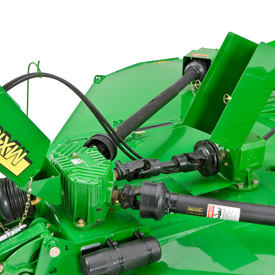 MX15 splitter and center gearcase
MX15 splitter and center gearcase
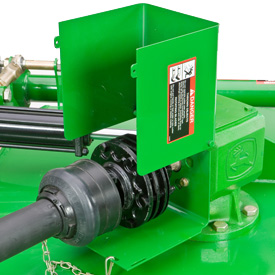 MX15 wing gearcase
MX15 wing gearcase
 MX15 round-pan blade holder (stump jumper)
MX15 round-pan blade holder (stump jumper)

Gearcases and blade holders provide the following:
- More horsepower
- Faster blade-tip speed
- Better performance
- Quieter operation
- Increased durability
The MX15 is equipped with a round-pan blade holder for optimum cut performance, material distribution, and gearbox protection.
The MX15 gearcases comes standard with a five year warranty.
Constant-velocity (CV) driveline is easy to attach
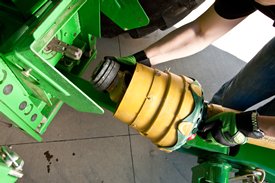 MX15 CV driveline
MX15 CV driveline
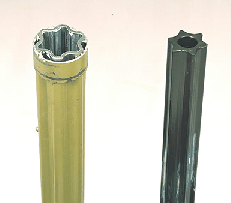 Six-lobe-star profile
Six-lobe-star profile
The tractor power take-off (PTO) is connected to the MX15 splitter gearbox by a CV, Category 5, tubular six-lobe-star-profile telescoping driveline that provides smooth operation while turning and going over variable terrain:
- Updated flex net design
- Complies with industry standards ASAE S331 and ISO 5673
A lightweight driveline with a lock-slide collar makes it fast and easy to attach.
Rigid axles provide a smooth ride
 MX15 rigid axles
MX15 rigid axles
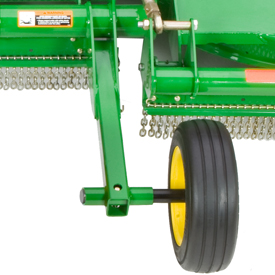 MX15 rigid axle detail
MX15 rigid axle detail
The MX15 is equipped with four rigid axle assemblies. The severe-duty agricultural tires that are teamed up to the axle assemblies provide a smooth ride for the terrain type and duty level for which the MX15 is designed.
Tight turns can be performed
 Tight turning radius (CX15 shown)
Tight turning radius (CX15 shown)

Hitches have a narrow profile and are 57.2 cm (22.5 in.) wide to allow a very tight turning radius.
Transport lock and wing locks offer a safe wing-up position
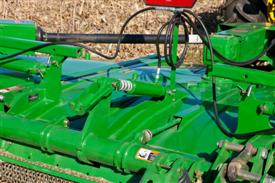 Rear cylinder transport lock in locked position
Rear cylinder transport lock in locked position

A transport lock flips over the lift cylinder for backup to the hydraulics when transporting the cutter.
The MX15 wing locks are located at the front-bottom section of the wings.
The wing cylinders lift and support the wings and the locks provide a secure wing-up position for transport, storage, and servicing.
The heavier HX and CX flex wings have spring-loaded wing arms with wing locks.
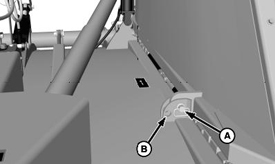 Wing lock in locked position
Wing lock in locked position

A - Pin locking position
B - Pin storage when the wing is down
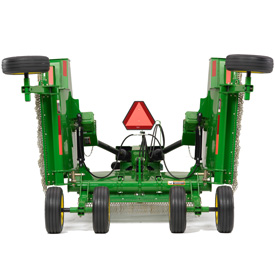 MX15 in transport mode*
MX15 in transport mode*

*The MX15 is shown with optional dual center wheels.
Serviceability
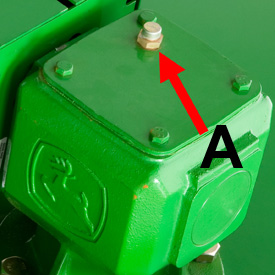 Gearcase with oil-level dipstick (A)
Gearcase with oil-level dipstick (A)
 Oil-level dipstick detail
Oil-level dipstick detail
Gearcases are provided with oil-level dipsticks.
Spring-loaded check valve vents are provided to release any air pressure that might build up within the gearcase and to keep the rotary cutter deck free of oil that would otherwise spew out of permanently open vents.
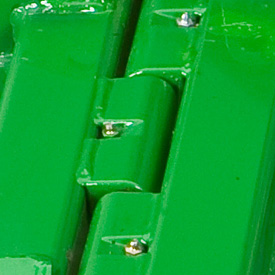 Wing hinge grease zerks
Wing hinge grease zerks
 Bellcrank grease zerks
Bellcrank grease zerks
All pivoting points that would benefit from greasing are provided with grease zerks. Wing hinges in particular are provided with individual grease zerks. It is important to note that these points require greasing infrequently; lubrication is for protection against seizing, not wear.
Hydraulic parking system makes cutter leveling easy and safe
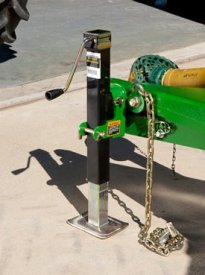 Hydraulic parking system
Hydraulic parking system

The MX15, like the HX15, CX15, HX20, and CX20, comes standard with an industry-exclusive hydraulically operated parking system with a swing-away parking stand that makes raising and lowering the cutter easy and safe. In addition, the manual implement jack is in base equipment so hitch leveling can be adjusted without hydraulics. With this addition, the cutter will remain in the same position for long time periods.
Features
What is the best cutter for your job?
NOTE: Only for single spindle and multi-spindle.
John Deere rotary cutters lead the way with innovative design, superior performance, and proven durability. Valuable features such as the Double-Decker™ design and Max Flow cutting chamber prevent water and debris from accumulating on the smooth, dome-shaped top deck while the flat bottom deck absorbs the punishment from rocks and stumps.
The top deck stays smooth - no dents, no dings, no holes. The internal supports sandwiched between the top and bottom decks are key to the smooth and structure-free Max Flow cutting chamber, while at the same time provide added strength and durability.
To help promote safe operation, John Deere rotary cutters are equipped with front and rear safety-chain shields. John Deere rotary cutters continue to advance in value with powerful gearboxes, blade holders, and compatibility with a wide range of tractors.
Here are situations when a rotary cutter provides value:
-
Clipping pastures encourages grass growth, optimizing valuable pasture acreage.
-
Cutting grass and stalks helps control insects.
-
Routine cutting keeps weeds from reseeding.
-
It is the most cost efficient way to cut roadsides, parks, cemeteries, airport fields, hydro, gas, and telephone easements, and all other types of open properties.
-
Cutting grass waterways encourages root development and helps prevent erosion.
-
Knocking down stalks such as cotton, corn, or milo speeds up decomposition. This is essential in no-till and minimum-till fields.
-
Clearing out brush.
-
Control undergrowth and grass in orchards, vineyards, and groves.
Decide what model to use based on:
- The size of the area to mow versus the size of the machine – the bigger the area to mow, the bigger the mower needs to be in order to be efficient during mowing hours. Similarly, the limitation of a small area will guide operators to use a smaller mower.
- The amount of time and frequency it will be used – for longer hours and more frequency, choose a heavier duty machine.
- Tractor compatibility – if there is a tractor the operator will be using, look for the tractor compatibility sheet to identify appropriate options.
John Deere rotary cutters are available in two duty-level categories:
-
Mid-duty
-
MX models are available in 1.5-m (5-ft), 1.8-m (6-ft), 2.1-m (7-ft), 2.5-m (8-ft), and 3.2-m (10-ft).
-
This duty-level category cuts brush up to 50.8 mm (2 in.) in diameter.
-
-
Heavy-duty
-
HX models are available in 3.2-m (10-ft) and 4.2-m (14-ft).
- This duty-level category cuts brush up to 76.2 mm (3 in.) in diameter.
-
HX6 is available in 1.8-m (6-ft) and the HX7 is available in 2.1-m (7-ft) cut widths; they cut brush up to 101.6 mm (4 in.) in diameter.
-
NOTE: HX models are heavier built to cut at a 101.6 mm (4 in.) capacity level more frequently and for longer durations.
Patented John Deere Double-Decker™ design for superior frame strength
 Cross-section of exclusive Double-Decker design
Cross-section of exclusive Double-Decker design

The patented Double-Decker design improves strength and cutting performance while reducing top deck rust. Two welded decks include a 3-mm (11-gauge, 0.118-in.) to 3.5-mm (10-gauge, 0.138-in.) thick upper deck, depending on the model, and a 3-mm (11-gauge, 0.118-in.) to 4.5-mm (7-gauge, 0.177-in.) thick lower deck, depending on the model.
Internal stiffeners are sandwiched between the decks to add extra strength and rigidity.
The Double-Decker design also provides a sturdy base to support the gearcases. Gearcases need this sturdy base to resist the bending loads imposed upon them when blades contact immovable objects or the ground.
The bottom deck is the main defense against rocks and field debris, to help protect the top deck from impacts so it will retain its smooth form.
Gearcases and blade holders provide better performance
 Gearcase and blade holder shown
Gearcase and blade holder shown
The John Deere gearboxes:
- Large seals
- Large housing
- Large output shaft
- Precision forged bevel gears
- Large bearings
- Stump jumper
Re-engineered gearcases and blade holders provide the following:
-
More horsepower
-
Faster blade-tip speed
-
Better performance
-
Quieter operation
-
Increased durability
Larger, more durable gearcases
Gearcases are John Deere designed for reliability and dependability:
- Center gearcase – 160 continuous hp or 200 peak hp
- Outer gearcase – 100 continuous hp or 150 peak hp
Heavy-duty, tapered roller bearings and precision gears help ensure long life.
Output shafts are splined, not just keyed, for extra strength and durability.
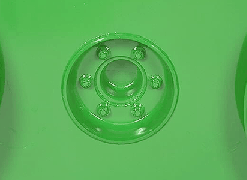 Heavy-duty bowl support
Heavy-duty bowl support

Gearcases mount on heavy-duty bowl supports, which are continuously welded to the top and bottom decks. These bowls provide a lifelong base of support for the gearcase/blade holder mechanism.
The HX14 comes standard with five year warranty.
Blades ensure clean cutting and fine shredding
Suction blades
 Suction blade
Suction blade

Suction blades provide additional lift action for picking up downed material. The blades are 1.3 cm x 10.2 cm (0.5 in. x 4 in.) in size and heat-treated for long wear life.
A fast blade-tip speed (up to 16889 fpm) ensures clean cutting and fine shredding of material.
Flat blades
 Flat blade
Flat blade

Flat blades are effective for any materials not downed and require suction for lifting.
Flat blades require less horsepower and have a cutting edge on both sides. Only available with double-blade system.
Dual blades (bar-type bladeholder only)
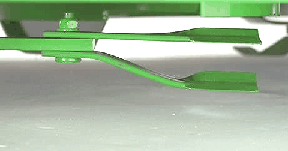 Dual blades
Dual blades

Dual blades are effective for increased shredding of crop residue.
The dual blades consist of a 1.3-cm x 10.2-cm (1/2-in. x 4-in.) lower suction blade and a 1.3-cm x 7.6-cm (1/2-in. x 3-in.) upper suction blade.
Tractor hookup available in two configurations
Lift type
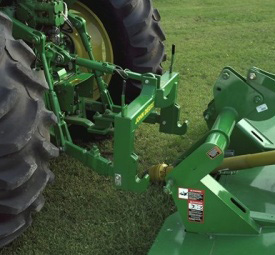 Lift type (shown with iMatch™ hitch system)
Lift type (shown with iMatch™ hitch system)

The lift-type versions fit tractors with Category 2, 3, or 3N 3-point hitches (with or without Quick Hitch).
NOTE: The lift-type versions require a larger tractor than other versions. For HX10 Lift-Type Rotary Cutters, the minimum-size tractor recommended is a 6020 Series or equivalent. For HX14 Lift-Type Rotary Cutters, the minimum-size tractor recommended is a 7720 or equivalent. Refer to the tractor's operator's manual for ballasting instructions. The pull-type versions of the HX10 Multi-Spindle Rotary Cutter require a tractor with a minimum of 50 power take-off (PTO) hp. The HX14 pull-type versions require a tractor with a minimum of 60 PTO hp. Note that the type and volume of material being cut affect horsepower requirements.
Pull type
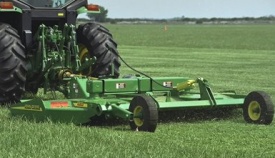 Pull type
Pull type

Parallel lift linkage helps keep the cutter level through all height adjustments. Cylinders are John Deere manufactured, meaning more reliability and durability.
Warranty
Five-year limited gearbox warranty provided on every John Deere rotary cutter
 Five-year warranty on all flex-wing gearboxes
Five-year warranty on all flex-wing gearboxes
 Five-year warranty on all rotary cutter gearboxes
Five-year warranty on all rotary cutter gearboxes
John Deere is so confident in the reliability of the gearbox that rotary cutters come with a 5-year limited gearbox warranty.
There is also 1-year warranty on the complete machine, as well as drivelines and other components.
Features
What is the best cutter for your job?
NOTE: Only for single spindle and multi-spindle.
John Deere rotary cutters lead the way with innovative design, superior performance, and proven durability. Valuable features such as the Double-Decker™ design and Max Flow cutting chamber prevent water and debris from accumulating on the smooth, dome-shaped top deck while the flat bottom deck absorbs the punishment from rocks and stumps.
The top deck stays smooth - no dents, no dings, no holes. The internal supports sandwiched between the top and bottom decks are key to the smooth and structure-free Max Flow cutting chamber, while at the same time provide added strength and durability.
To help promote safe operation, John Deere rotary cutters are equipped with front and rear safety-chain shields. John Deere rotary cutters continue to advance in value with powerful gearboxes, blade holders, and compatibility with a wide range of tractors.
Here are situations when a rotary cutter provides value:
-
Clipping pastures encourages grass growth, optimizing valuable pasture acreage.
-
Cutting grass and stalks helps control insects.
-
Routine cutting keeps weeds from reseeding.
-
It is the most cost efficient way to cut roadsides, parks, cemeteries, airport fields, hydro, gas, and telephone easements, and all other types of open properties.
-
Cutting grass waterways encourages root development and helps prevent erosion.
-
Knocking down stalks such as cotton, corn, or milo speeds up decomposition. This is essential in no-till and minimum-till fields.
-
Clearing out brush.
-
Control undergrowth and grass in orchards, vineyards, and groves.
Decide what model to use based on:
- The size of the area to mow versus the size of the machine – the bigger the area to mow, the bigger the mower needs to be in order to be efficient during mowing hours. Similarly, the limitation of a small area will guide operators to use a smaller mower.
- The amount of time and frequency it will be used – for longer hours and more frequency, choose a heavier duty machine.
- Tractor compatibility – if there is a tractor the operator will be using, look for the tractor compatibility sheet to identify appropriate options.
John Deere rotary cutters are available in two duty-level categories:
-
Mid-duty
-
MX models are available in 1.5-m (5-ft), 1.8-m (6-ft), 2.1-m (7-ft), 2.5-m (8-ft), and 3.2-m (10-ft).
-
This duty-level category cuts brush up to 50.8 mm (2 in.) in diameter.
-
-
Heavy-duty
-
HX models are available in 3.2-m (10-ft) and 4.2-m (14-ft).
- This duty-level category cuts brush up to 76.2 mm (3 in.) in diameter.
-
HX6 is available in 1.8-m (6-ft) and the HX7 is available in 2.1-m (7-ft) cut widths; they cut brush up to 101.6 mm (4 in.) in diameter.
-
NOTE: HX models are heavier built to cut at a 101.6 mm (4 in.) capacity level more frequently and for longer durations.
Patented John Deere Double-Decker™ design for superior frame strength
 Cross-section of exclusive Double-Decker design
Cross-section of exclusive Double-Decker design

The patented Double-Decker design improves strength and cutting performance while reducing top deck rust. Two welded decks include a 3-mm (11-gauge, 0.118-in.) to 3.5-mm (10-gauge, 0.138-in.) thick upper deck, depending on the model, and a 3-mm (11-gauge, 0.118-in.) to 4.5-mm (7-gauge, 0.177-in.) thick lower deck, depending on the model.
Internal stiffeners are sandwiched between the decks to add extra strength and rigidity.
The Double-Decker design also provides a sturdy base to support the gearcases. Gearcases need this sturdy base to resist the bending loads imposed upon them when blades contact immovable objects or the ground.
The bottom deck is the main defense against rocks and field debris, to help protect the top deck from impacts so it will retain its smooth form.
Gearcases and blade holders provide better performance
 Gearcase and blade holder shown
Gearcase and blade holder shown
The John Deere gearboxes:
- Large seals
- Large housing
- Large output shaft
- Precision forged bevel gears
- Large bearings
- Stump jumper
Re-engineered gearcases and blade holders provide the following:
-
More horsepower
-
Faster blade-tip speed
-
Better performance
-
Quieter operation
-
Increased durability
Larger, more durable gearboxes
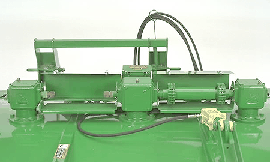 HX10 gearcases
HX10 gearcases

Gearcases are John Deere engineered for reliability and dependability.
- Transfer (center gearcase) – 120 continuous hp or 180 peak hp
- Outer gearcases – 100 continuous hp or 140 peak hp
Heavy-duty, tapered roller bearings and precision gears help ensure long life.
Output shafts are splined, not just keyed, for extra strength and durability.
 Heavy-duty bowl support
Heavy-duty bowl support

Gearcases mount on heavy-duty bowl supports, which are continuously welded to the top and bottom decks. These bowls provide a lifelong base of support for the gearcase/blade holder mechanism.
The HX10 model comes standard with five year warranty.
Blades ensure clean cutting and fine shredding
Suction blades
 Suction blade
Suction blade

Suction blades provide additional lift action for picking up downed material. The blades are 1.3 cm x 10.2 cm (0.5 in. x 4 in.) in size and heat-treated for long wear life.
A fast blade-tip speed (up to 16889 fpm) ensures clean cutting and fine shredding of material.
Flat blades
 Flat blade
Flat blade

Flat blades are effective for any materials not downed and require suction for lifting.
Flat blades require less horsepower and have a cutting edge on both sides. Only available with double-blade system.
Dual blades (bar-type bladeholder only)
 Dual blades
Dual blades

Dual blades are effective for increased shredding of crop residue.
The dual blades consist of a 1.3-cm x 10.2-cm (1/2-in. x 4-in.) lower suction blade and a 1.3-cm x 7.6-cm (1/2-in. x 3-in.) upper suction blade.
Tractor hookup available in two configurations
Lift type
 Lift type (shown with iMatch™ hitch system)
Lift type (shown with iMatch™ hitch system)

The lift-type versions fit tractors with Category 2, 3, or 3N 3-point hitches (with or without Quick Hitch).
NOTE: The lift-type versions require a larger tractor than other versions. For HX10 Lift-Type Rotary Cutters, the minimum-size tractor recommended is a 6020 Series or equivalent. For HX14 Lift-Type Rotary Cutters, the minimum-size tractor recommended is a 7720 or equivalent. Refer to the tractor's operator's manual for ballasting instructions. The pull-type versions of the HX10 Multi-Spindle Rotary Cutter require a tractor with a minimum of 50 power take-off (PTO) hp. The HX14 pull-type versions require a tractor with a minimum of 60 PTO hp. Note that the type and volume of material being cut affect horsepower requirements.
Pull type
 Pull type
Pull type

Parallel lift linkage helps keep the cutter level through all height adjustments. Cylinders are John Deere manufactured, meaning more reliability and durability.
Warranty
Five-year limited gearbox warranty provided on every John Deere rotary cutter
 Five-year warranty on all flex-wing gearboxes
Five-year warranty on all flex-wing gearboxes
 Five-year warranty on all rotary cutter gearboxes
Five-year warranty on all rotary cutter gearboxes
John Deere is so confident in the reliability of the gearbox that rotary cutters come with a 5-year limited gearbox warranty.
There is also 1-year warranty on the complete machine, as well as drivelines and other components.
Features
What is the best cutter for your job?
NOTE: Only for single spindle and multi-spindle.
John Deere rotary cutters lead the way with innovative design, superior performance, and proven durability. Valuable features such as the Double-Decker™ design and Max Flow cutting chamber prevent water and debris from accumulating on the smooth, dome-shaped top deck while the flat bottom deck absorbs the punishment from rocks and stumps.
The top deck stays smooth - no dents, no dings, no holes. The internal supports sandwiched between the top and bottom decks are key to the smooth and structure-free Max Flow cutting chamber, while at the same time provide added strength and durability.
To help promote safe operation, John Deere rotary cutters are equipped with front and rear safety-chain shields. John Deere rotary cutters continue to advance in value with powerful gearboxes, blade holders, and compatibility with a wide range of tractors.
Here are situations when a rotary cutter provides value:
-
Clipping pastures encourages grass growth, optimizing valuable pasture acreage.
-
Cutting grass and stalks helps control insects.
-
Routine cutting keeps weeds from reseeding.
-
It is the most cost efficient way to cut roadsides, parks, cemeteries, airport fields, hydro, gas, and telephone easements, and all other types of open properties.
-
Cutting grass waterways encourages root development and helps prevent erosion.
-
Knocking down stalks such as cotton, corn, or milo speeds up decomposition. This is essential in no-till and minimum-till fields.
-
Clearing out brush.
-
Control undergrowth and grass in orchards, vineyards, and groves.
Decide what model to use based on:
- The size of the area to mow versus the size of the machine – the bigger the area to mow, the bigger the mower needs to be in order to be efficient during mowing hours. Similarly, the limitation of a small area will guide operators to use a smaller mower.
- The amount of time and frequency it will be used – for longer hours and more frequency, choose a heavier duty machine.
- Tractor compatibility – if there is a tractor the operator will be using, look for the tractor compatibility sheet to identify appropriate options.
John Deere rotary cutters are available in two duty-level categories:
-
Mid-duty
-
MX models are available in 1.5-m (5-ft), 1.8-m (6-ft), 2.1-m (7-ft), 2.5-m (8-ft), and 3.2-m (10-ft).
-
This duty-level category cuts brush up to 50.8 mm (2 in.) in diameter.
-
-
Heavy-duty
-
HX models are available in 3.2-m (10-ft) and 4.2-m (14-ft).
- This duty-level category cuts brush up to 76.2 mm (3 in.) in diameter.
-
HX6 is available in 1.8-m (6-ft) and the HX7 is available in 2.1-m (7-ft) cut widths; they cut brush up to 101.6 mm (4 in.) in diameter.
-
NOTE: HX models are heavier built to cut at a 101.6 mm (4 in.) capacity level more frequently and for longer durations.
Double-Decker™ helps to maintain your cutter clean
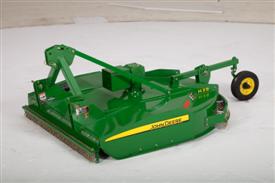 Exclusive double-deck in HX6
Exclusive double-deck in HX6

All the MX, HX, and CX Rotary Cutters have the patented Double-Decker™ design. The smooth
dome-shaped decks provide easy cleaning and water runs off for longer product life. Deck thickness increases as the size and cutter duty level increases.
Gearcases and blade holders provide better performance
 Gearcase and blade holder shown
Gearcase and blade holder shown
The John Deere gearboxes:
- Large seals
- Large housing
- Large output shaft
- Precision forged bevel gears
- Large bearings
- Stump jumper
Re-engineered gearcases and blade holders provide the following:
-
More horsepower
-
Faster blade-tip speed
-
Better performance
-
Quieter operation
-
Increased durability
Heavy-duty John Deere-designed gearcases
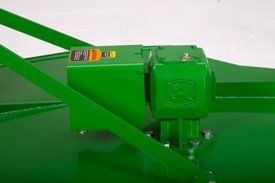 Heavy-duty gearcase
Heavy-duty gearcase

The heavy-duty gearcase with non-seize self-adjusting slip-clutch driveline is shown at left.
The gearcase horsepower rating is as follows:
- 150 hp (112 kW) continuous
- 210 hp (157 kW) peak
Cast-metal gearcase features:
- Tapered roller bearings and forged gears for longer life (forged gears are stronger because as the gear is heat-forged into shape, the grain of the metal actually changes to follow the outline of the teeth).
- Output shafts are splined, not just keyed, for extra strength.
- Gearcase is solidly mounted to the frame for a long, trouble-free life.
-
Six mounting bolts (not four) are used.
- Possibility of flange locknuts fracturing from stress or working loose in tough operating conditions is reduced.
- Frame metal underneath the gearcase is double thickness for more strength.
-
The factory preset, four-plate slip clutch protects the driveline:
- Especially valuable when operating in brush
- Preset at the factory and never needs adjusting
-
Fully shielded driveline for safety
The HX6 and HX7 gearcases come standard with a five-year warranty.
Deep-cutting chamber provides a better shredding action
 HX6 and HX7 deliver a clean cut
HX6 and HX7 deliver a clean cut

The fast blade-tip speed ensures clean cutting and fine shredding of material.
- HX6: 13,623 fpm (69.2 m/sec) and 155 mph
- HX7: 16,061 fpm (81.6 m/sec) and 183 mph
A forward tip adjustment allows the cutter to be tilted forward slightly, so most of the cutting occurs in the front while the shredding action occurs toward the rear:
- Improves cutting job
- Reduces horsepower requirements
The tapered rear opening spreads shredded material across entire width of cut:
- Reduces windrowing
- Leaves an even blanket of mulch
Front and rear safety chains are standard for increased protection
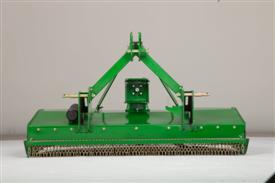 Front safety chain shield
Front safety chain shield
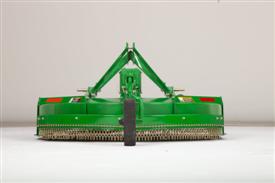 Rear safety chain shield
Rear safety chain shield
Front and rear safety chain shields are standard equipment. They offer protection yet allow material to pass into the cutting area with minimal obstruction:
- They help deflect thrown material and improve shredding.
Warranty
Five-year limited gearbox warranty provided on every John Deere rotary cutter
 Five-year warranty on all flex-wing gearboxes
Five-year warranty on all flex-wing gearboxes
 Five-year warranty on all rotary cutter gearboxes
Five-year warranty on all rotary cutter gearboxes
John Deere is so confident in the reliability of the gearbox that rotary cutters come with a 5-year limited gearbox warranty.
There is also 1-year warranty on the complete machine, as well as drivelines and other components.
Features
What is the best cutter for your job?
NOTE: Only for single spindle and multi-spindle.
John Deere rotary cutters lead the way with innovative design, superior performance, and proven durability. Valuable features such as the Double-Decker™ design and Max Flow cutting chamber prevent water and debris from accumulating on the smooth, dome-shaped top deck while the flat bottom deck absorbs the punishment from rocks and stumps.
The top deck stays smooth - no dents, no dings, no holes. The internal supports sandwiched between the top and bottom decks are key to the smooth and structure-free Max Flow cutting chamber, while at the same time provide added strength and durability.
To help promote safe operation, John Deere rotary cutters are equipped with front and rear safety-chain shields. John Deere rotary cutters continue to advance in value with powerful gearboxes, blade holders, and compatibility with a wide range of tractors.
Here are situations when a rotary cutter provides value:
-
Clipping pastures encourages grass growth, optimizing valuable pasture acreage.
-
Cutting grass and stalks helps control insects.
-
Routine cutting keeps weeds from reseeding.
-
It is the most cost efficient way to cut roadsides, parks, cemeteries, airport fields, hydro, gas, and telephone easements, and all other types of open properties.
-
Cutting grass waterways encourages root development and helps prevent erosion.
-
Knocking down stalks such as cotton, corn, or milo speeds up decomposition. This is essential in no-till and minimum-till fields.
-
Clearing out brush.
-
Control undergrowth and grass in orchards, vineyards, and groves.
Decide what model to use based on:
- The size of the area to mow versus the size of the machine – the bigger the area to mow, the bigger the mower needs to be in order to be efficient during mowing hours. Similarly, the limitation of a small area will guide operators to use a smaller mower.
- The amount of time and frequency it will be used – for longer hours and more frequency, choose a heavier duty machine.
- Tractor compatibility – if there is a tractor the operator will be using, look for the tractor compatibility sheet to identify appropriate options.
John Deere rotary cutters are available in two duty-level categories:
-
Mid-duty
-
MX models are available in 1.5-m (5-ft), 1.8-m (6-ft), 2.1-m (7-ft), 2.5-m (8-ft), and 3.2-m (10-ft).
-
This duty-level category cuts brush up to 50.8 mm (2 in.) in diameter.
-
-
Heavy-duty
-
HX models are available in 3.2-m (10-ft) and 4.2-m (14-ft).
- This duty-level category cuts brush up to 76.2 mm (3 in.) in diameter.
-
HX6 is available in 1.8-m (6-ft) and the HX7 is available in 2.1-m (7-ft) cut widths; they cut brush up to 101.6 mm (4 in.) in diameter.
-
NOTE: HX models are heavier built to cut at a 101.6 mm (4 in.) capacity level more frequently and for longer durations.
Double-Decker™ helps to maintain your cutter clean
 Exclusive double-deck in HX6
Exclusive double-deck in HX6

All the MX, HX, and CX Rotary Cutters have the patented Double-Decker™ design. The smooth
dome-shaped decks provide easy cleaning and water runs off for longer product life. Deck thickness increases as the size and cutter duty level increases.
Gearcases and blade holders provide better performance
 Gearcase and blade holder shown
Gearcase and blade holder shown
The John Deere gearboxes:
- Large seals
- Large housing
- Large output shaft
- Precision forged bevel gears
- Large bearings
- Stump jumper
Re-engineered gearcases and blade holders provide the following:
-
More horsepower
-
Faster blade-tip speed
-
Better performance
-
Quieter operation
-
Increased durability
Heavy-duty John Deere-designed gearcases
 Heavy-duty gearcase
Heavy-duty gearcase

The heavy-duty gearcase with non-seize self-adjusting slip-clutch driveline is shown at left.
The gearcase horsepower rating is as follows:
- 150 hp (112 kW) continuous
- 210 hp (157 kW) peak
Cast-metal gearcase features:
- Tapered roller bearings and forged gears for longer life (forged gears are stronger because as the gear is heat-forged into shape, the grain of the metal actually changes to follow the outline of the teeth).
- Output shafts are splined, not just keyed, for extra strength.
- Gearcase is solidly mounted to the frame for a long, trouble-free life.
-
Six mounting bolts (not four) are used.
- Possibility of flange locknuts fracturing from stress or working loose in tough operating conditions is reduced.
- Frame metal underneath the gearcase is double thickness for more strength.
-
The factory preset, four-plate slip clutch protects the driveline:
- Especially valuable when operating in brush
- Preset at the factory and never needs adjusting
-
Fully shielded driveline for safety
The HX6 and HX7 gearcases come standard with a five-year warranty.
Deep-cutting chamber provides a better shredding action
 HX6 and HX7 deliver a clean cut
HX6 and HX7 deliver a clean cut

The fast blade-tip speed ensures clean cutting and fine shredding of material.
- HX6: 13,623 fpm (69.2 m/sec) and 155 mph
- HX7: 16,061 fpm (81.6 m/sec) and 183 mph
A forward tip adjustment allows the cutter to be tilted forward slightly, so most of the cutting occurs in the front while the shredding action occurs toward the rear:
- Improves cutting job
- Reduces horsepower requirements
The tapered rear opening spreads shredded material across entire width of cut:
- Reduces windrowing
- Leaves an even blanket of mulch
Front and rear safety chains are standard for increased protection
 Front safety chain shield
Front safety chain shield
 Rear safety chain shield
Rear safety chain shield
Front and rear safety chain shields are standard equipment. They offer protection yet allow material to pass into the cutting area with minimal obstruction:
- They help deflect thrown material and improve shredding.
Warranty
Five-year limited gearbox warranty provided on every John Deere rotary cutter
 Five-year warranty on all flex-wing gearboxes
Five-year warranty on all flex-wing gearboxes
 Five-year warranty on all rotary cutter gearboxes
Five-year warranty on all rotary cutter gearboxes
John Deere is so confident in the reliability of the gearbox that rotary cutters come with a 5-year limited gearbox warranty.
There is also 1-year warranty on the complete machine, as well as drivelines and other components.
Features
What is the best cutter for your job?
NOTE: Only for single spindle and multi-spindle.
John Deere rotary cutters lead the way with innovative design, superior performance, and proven durability. Valuable features such as the Double-Decker™ design and Max Flow cutting chamber prevent water and debris from accumulating on the smooth, dome-shaped top deck while the flat bottom deck absorbs the punishment from rocks and stumps.
The top deck stays smooth - no dents, no dings, no holes. The internal supports sandwiched between the top and bottom decks are key to the smooth and structure-free Max Flow cutting chamber, while at the same time provide added strength and durability.
To help promote safe operation, John Deere rotary cutters are equipped with front and rear safety-chain shields. John Deere rotary cutters continue to advance in value with powerful gearboxes, blade holders, and compatibility with a wide range of tractors.
Here are situations when a rotary cutter provides value:
-
Clipping pastures encourages grass growth, optimizing valuable pasture acreage.
-
Cutting grass and stalks helps control insects.
-
Routine cutting keeps weeds from reseeding.
-
It is the most cost efficient way to cut roadsides, parks, cemeteries, airport fields, hydro, gas, and telephone easements, and all other types of open properties.
-
Cutting grass waterways encourages root development and helps prevent erosion.
-
Knocking down stalks such as cotton, corn, or milo speeds up decomposition. This is essential in no-till and minimum-till fields.
-
Clearing out brush.
-
Control undergrowth and grass in orchards, vineyards, and groves.
Decide what model to use based on:
- The size of the area to mow versus the size of the machine – the bigger the area to mow, the bigger the mower needs to be in order to be efficient during mowing hours. Similarly, the limitation of a small area will guide operators to use a smaller mower.
- The amount of time and frequency it will be used – for longer hours and more frequency, choose a heavier duty machine.
- Tractor compatibility – if there is a tractor the operator will be using, look for the tractor compatibility sheet to identify appropriate options.
John Deere rotary cutters are available in two duty-level categories:
-
Mid-duty
-
MX models are available in 1.5-m (5-ft), 1.8-m (6-ft), 2.1-m (7-ft), 2.5-m (8-ft), and 3.2-m (10-ft).
-
This duty-level category cuts brush up to 50.8 mm (2 in.) in diameter.
-
-
Heavy-duty
-
HX models are available in 3.2-m (10-ft) and 4.2-m (14-ft).
- This duty-level category cuts brush up to 76.2 mm (3 in.) in diameter.
-
HX6 is available in 1.8-m (6-ft) and the HX7 is available in 2.1-m (7-ft) cut widths; they cut brush up to 101.6 mm (4 in.) in diameter.
-
NOTE: HX models are heavier built to cut at a 101.6 mm (4 in.) capacity level more frequently and for longer durations.
Industry-exclusive Double-Decker™ frame design
 Cross-section of patented Double-Decker design
Cross-section of patented Double-Decker design

The patented Double-Decker design provides strength and superior cutting performance while reducing top deck rust. Two welded decks, each 3-mm (1/8-in.) thick, form the upper and lower surfaces of the rotary cutter frame.
Internal stiffeners are sandwiched between the two decks, providing superior strength and rigidity.
The top deck is domed. Water, grass, and crop debris tend to roll off the deck, reducing water buildup and deck rust. The domed shape and smooth profile of the top deck also make the deck easier to clean when trash does build up in adverse conditions.
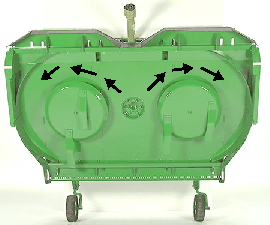 Unobstructed horizontal bottom deck
Unobstructed horizontal bottom deck

The bottom deck is the main defense against rocks and field debris. Therefore, the top deck is continuously protected from impacts and tends to retain its smooth form.
Because the stiffeners are located between the two decks, the underside of the bottom deck is perfectly smooth; there are no structural frame members to interrupt airflow. This improves both cutting performance and distribution.
Standard material flow deflectors help channel the cut material, further improving material distribution.
Driveline with slip clutch helps protect it against overloads
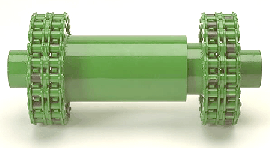 Rubber element driveline with chain couplers
Rubber element driveline with chain couplers
Rubber element connecting drivelines help absorb the sudden stress of impact loads. Chain couplers are used to maintain the driveline alignment.
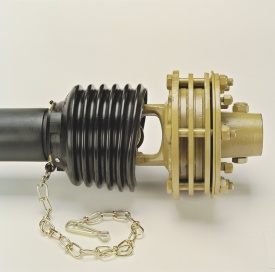 Slip-clutch driveline
Slip-clutch driveline
A non-seize slip clutch used between the primary gearcase and power take-off (PTO) helps protect the driveline. Slip clutches feature a spring-compression adjustment used to ensure clutches are not seized.
Lift-type and semi-mount models feature an ASAE Category 4 driveline for added durability.
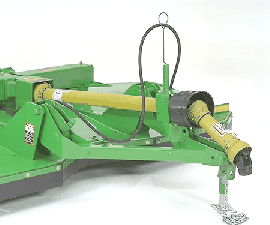 Equal-angle driveline
Equal-angle driveline
The pull-type model uses an equal-angle driveline for smoother, rattle-free turns.
A lightweight driveline with a lock-slide collar makes it fast and easy to attach.
The driveline provides long lubrication periods; a 50-hour cycle reduces maintenance time, making the cutting operation more efficient.
Safety chain shields are standard
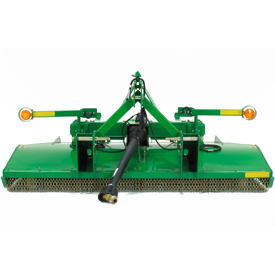 Front safety chains (MX8 shown)
Front safety chains (MX8 shown)
 Rear safety chains (MX8 shown)
Rear safety chains (MX8 shown)
Front and rear chain shields are standard equipment:
- Offer protection during operation yet allow uncut material to pass into the cutting chamber with minimal restriction
Standard stump jumper blade holder provides protection against impacts
Round-pan blade holders (stump jumpers) are provided as standard equipment on most John Deere rotary cutter models. Stump jumpers increase the drivetrain reliability by providing protection against impacts such as stumps, rocks, and other obstacles.
Warranty
Five-year limited gearbox warranty provided on every John Deere rotary cutter
 Five-year warranty on all flex-wing gearboxes
Five-year warranty on all flex-wing gearboxes
 Five-year warranty on all rotary cutter gearboxes
Five-year warranty on all rotary cutter gearboxes
John Deere is so confident in the reliability of the gearbox that rotary cutters come with a 5-year limited gearbox warranty.
There is also 1-year warranty on the complete machine, as well as drivelines and other components.
Features
What is the best cutter for your job?
NOTE: Only for single spindle and multi-spindle.
John Deere rotary cutters lead the way with innovative design, superior performance, and proven durability. Valuable features such as the Double-Decker™ design and Max Flow cutting chamber prevent water and debris from accumulating on the smooth, dome-shaped top deck while the flat bottom deck absorbs the punishment from rocks and stumps.
The top deck stays smooth - no dents, no dings, no holes. The internal supports sandwiched between the top and bottom decks are key to the smooth and structure-free Max Flow cutting chamber, while at the same time provide added strength and durability.
To help promote safe operation, John Deere rotary cutters are equipped with front and rear safety-chain shields. John Deere rotary cutters continue to advance in value with powerful gearboxes, blade holders, and compatibility with a wide range of tractors.
Here are situations when a rotary cutter provides value:
-
Clipping pastures encourages grass growth, optimizing valuable pasture acreage.
-
Cutting grass and stalks helps control insects.
-
Routine cutting keeps weeds from reseeding.
-
It is the most cost efficient way to cut roadsides, parks, cemeteries, airport fields, hydro, gas, and telephone easements, and all other types of open properties.
-
Cutting grass waterways encourages root development and helps prevent erosion.
-
Knocking down stalks such as cotton, corn, or milo speeds up decomposition. This is essential in no-till and minimum-till fields.
-
Clearing out brush.
-
Control undergrowth and grass in orchards, vineyards, and groves.
Decide what model to use based on:
- The size of the area to mow versus the size of the machine – the bigger the area to mow, the bigger the mower needs to be in order to be efficient during mowing hours. Similarly, the limitation of a small area will guide operators to use a smaller mower.
- The amount of time and frequency it will be used – for longer hours and more frequency, choose a heavier duty machine.
- Tractor compatibility – if there is a tractor the operator will be using, look for the tractor compatibility sheet to identify appropriate options.
John Deere rotary cutters are available in two duty-level categories:
-
Mid-duty
-
MX models are available in 1.5-m (5-ft), 1.8-m (6-ft), 2.1-m (7-ft), 2.5-m (8-ft), and 3.2-m (10-ft).
-
This duty-level category cuts brush up to 50.8 mm (2 in.) in diameter.
-
-
Heavy-duty
-
HX models are available in 3.2-m (10-ft) and 4.2-m (14-ft).
- This duty-level category cuts brush up to 76.2 mm (3 in.) in diameter.
-
HX6 is available in 1.8-m (6-ft) and the HX7 is available in 2.1-m (7-ft) cut widths; they cut brush up to 101.6 mm (4 in.) in diameter.
-
NOTE: HX models are heavier built to cut at a 101.6 mm (4 in.) capacity level more frequently and for longer durations.
Industry-exclusive Double-Decker™ frame design
 Cross-section of patented Double-Decker design
Cross-section of patented Double-Decker design

The patented Double-Decker design provides strength and superior cutting performance while reducing top deck rust. Two welded decks, each 3-mm (1/8-in.) thick, form the upper and lower surfaces of the rotary cutter frame.
Internal stiffeners are sandwiched between the two decks, providing superior strength and rigidity.
The top deck is domed. Water, grass, and crop debris tend to roll off the deck, reducing water buildup and deck rust. The domed shape and smooth profile of the top deck also make the deck easier to clean when trash does build up in adverse conditions.
 Unobstructed horizontal bottom deck
Unobstructed horizontal bottom deck

The bottom deck is the main defense against rocks and field debris. Therefore, the top deck is continuously protected from impacts and tends to retain its smooth form.
Because the stiffeners are located between the two decks, the underside of the bottom deck is perfectly smooth; there are no structural frame members to interrupt airflow. This improves both cutting performance and distribution.
Standard material flow deflectors help channel the cut material, further improving material distribution.
Driveline with slip clutch helps protect it against overloads
 Rubber element driveline with chain couplers
Rubber element driveline with chain couplers
Rubber element connecting drivelines help absorb the sudden stress of impact loads. Chain couplers are used to maintain the driveline alignment.
 Slip-clutch driveline
Slip-clutch driveline
A non-seize slip clutch used between the primary gearcase and power take-off (PTO) helps protect the driveline. Slip clutches feature a spring-compression adjustment used to ensure clutches are not seized.
Lift-type and semi-mount models feature an ASAE Category 4 driveline for added durability.
 Equal-angle driveline
Equal-angle driveline
The pull-type model uses an equal-angle driveline for smoother, rattle-free turns.
A lightweight driveline with a lock-slide collar makes it fast and easy to attach.
The driveline provides long lubrication periods; a 50-hour cycle reduces maintenance time, making the cutting operation more efficient.
Safety chain shields are standard
 Front safety chains (MX8 shown)
Front safety chains (MX8 shown)
 Rear safety chains (MX8 shown)
Rear safety chains (MX8 shown)
Front and rear chain shields are standard equipment:
- Offer protection during operation yet allow uncut material to pass into the cutting chamber with minimal restriction
Standard stump jumper blade holder provides protection against impacts
Round-pan blade holders (stump jumpers) are provided as standard equipment on most John Deere rotary cutter models. Stump jumpers increase the drivetrain reliability by providing protection against impacts such as stumps, rocks, and other obstacles.
Warranty
Five-year limited gearbox warranty provided on every John Deere rotary cutter
 Five-year warranty on all flex-wing gearboxes
Five-year warranty on all flex-wing gearboxes
 Five-year warranty on all rotary cutter gearboxes
Five-year warranty on all rotary cutter gearboxes
John Deere is so confident in the reliability of the gearbox that rotary cutters come with a 5-year limited gearbox warranty.
There is also 1-year warranty on the complete machine, as well as drivelines and other components.
Features
What is the best cutter for your job?
NOTE: Only for single spindle and multi-spindle.
John Deere rotary cutters lead the way with innovative design, superior performance, and proven durability. Valuable features such as the Double-Decker™ design and Max Flow cutting chamber prevent water and debris from accumulating on the smooth, dome-shaped top deck while the flat bottom deck absorbs the punishment from rocks and stumps.
The top deck stays smooth - no dents, no dings, no holes. The internal supports sandwiched between the top and bottom decks are key to the smooth and structure-free Max Flow cutting chamber, while at the same time provide added strength and durability.
To help promote safe operation, John Deere rotary cutters are equipped with front and rear safety-chain shields. John Deere rotary cutters continue to advance in value with powerful gearboxes, blade holders, and compatibility with a wide range of tractors.
Here are situations when a rotary cutter provides value:
-
Clipping pastures encourages grass growth, optimizing valuable pasture acreage.
-
Cutting grass and stalks helps control insects.
-
Routine cutting keeps weeds from reseeding.
-
It is the most cost efficient way to cut roadsides, parks, cemeteries, airport fields, hydro, gas, and telephone easements, and all other types of open properties.
-
Cutting grass waterways encourages root development and helps prevent erosion.
-
Knocking down stalks such as cotton, corn, or milo speeds up decomposition. This is essential in no-till and minimum-till fields.
-
Clearing out brush.
-
Control undergrowth and grass in orchards, vineyards, and groves.
Decide what model to use based on:
- The size of the area to mow versus the size of the machine – the bigger the area to mow, the bigger the mower needs to be in order to be efficient during mowing hours. Similarly, the limitation of a small area will guide operators to use a smaller mower.
- The amount of time and frequency it will be used – for longer hours and more frequency, choose a heavier duty machine.
- Tractor compatibility – if there is a tractor the operator will be using, look for the tractor compatibility sheet to identify appropriate options.
John Deere rotary cutters are available in two duty-level categories:
-
Mid-duty
-
MX models are available in 1.5-m (5-ft), 1.8-m (6-ft), 2.1-m (7-ft), 2.5-m (8-ft), and 3.2-m (10-ft).
-
This duty-level category cuts brush up to 50.8 mm (2 in.) in diameter.
-
-
Heavy-duty
-
HX models are available in 3.2-m (10-ft) and 4.2-m (14-ft).
- This duty-level category cuts brush up to 76.2 mm (3 in.) in diameter.
-
HX6 is available in 1.8-m (6-ft) and the HX7 is available in 2.1-m (7-ft) cut widths; they cut brush up to 101.6 mm (4 in.) in diameter.
-
NOTE: HX models are heavier built to cut at a 101.6 mm (4 in.) capacity level more frequently and for longer durations.
Front and rear safety chain shields are standard
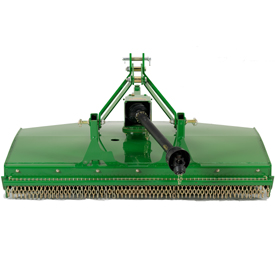 Front safety chains (MX6 shown)
Front safety chains (MX6 shown)
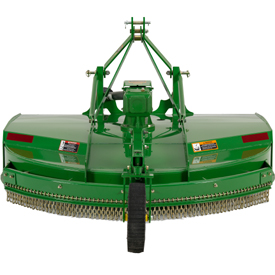 Rear safety chains (MX6 shown)
Rear safety chains (MX6 shown)
Front and rear chain shields are standard equipment:
- Offer protection for the operator yet allow uncut material to pass into the cutting chamber with minimal restriction
Standard suction blades provide additional blade lift
 Suction blade (standard equipment)
Suction blade (standard equipment)
Suction blades provide additional lift action for picking up downed material. The blades are 1.3 cm x 10.2 cm (0.5 in. x 4 in.) in size and heat-treated for long wear life.
The fast blade-tip speed ensures clean cutting and fine shredding of material.
- Up to 88.5 m/sec (17416 fpm)
Warranty
Five-year limited gearbox warranty provided on every John Deere rotary cutter
 Five-year warranty on all flex-wing gearboxes
Five-year warranty on all flex-wing gearboxes
 Five-year warranty on all rotary cutter gearboxes
Five-year warranty on all rotary cutter gearboxes
John Deere is so confident in the reliability of the gearbox that rotary cutters come with a 5-year limited gearbox warranty.
There is also 1-year warranty on the complete machine, as well as drivelines and other components.
Features
What is the best cutter for your job?
NOTE: Only for single spindle and multi-spindle.
John Deere rotary cutters lead the way with innovative design, superior performance, and proven durability. Valuable features such as the Double-Decker™ design and Max Flow cutting chamber prevent water and debris from accumulating on the smooth, dome-shaped top deck while the flat bottom deck absorbs the punishment from rocks and stumps.
The top deck stays smooth - no dents, no dings, no holes. The internal supports sandwiched between the top and bottom decks are key to the smooth and structure-free Max Flow cutting chamber, while at the same time provide added strength and durability.
To help promote safe operation, John Deere rotary cutters are equipped with front and rear safety-chain shields. John Deere rotary cutters continue to advance in value with powerful gearboxes, blade holders, and compatibility with a wide range of tractors.
Here are situations when a rotary cutter provides value:
-
Clipping pastures encourages grass growth, optimizing valuable pasture acreage.
-
Cutting grass and stalks helps control insects.
-
Routine cutting keeps weeds from reseeding.
-
It is the most cost efficient way to cut roadsides, parks, cemeteries, airport fields, hydro, gas, and telephone easements, and all other types of open properties.
-
Cutting grass waterways encourages root development and helps prevent erosion.
-
Knocking down stalks such as cotton, corn, or milo speeds up decomposition. This is essential in no-till and minimum-till fields.
-
Clearing out brush.
-
Control undergrowth and grass in orchards, vineyards, and groves.
Decide what model to use based on:
- The size of the area to mow versus the size of the machine – the bigger the area to mow, the bigger the mower needs to be in order to be efficient during mowing hours. Similarly, the limitation of a small area will guide operators to use a smaller mower.
- The amount of time and frequency it will be used – for longer hours and more frequency, choose a heavier duty machine.
- Tractor compatibility – if there is a tractor the operator will be using, look for the tractor compatibility sheet to identify appropriate options.
John Deere rotary cutters are available in two duty-level categories:
-
Mid-duty
-
MX models are available in 1.5-m (5-ft), 1.8-m (6-ft), 2.1-m (7-ft), 2.5-m (8-ft), and 3.2-m (10-ft).
-
This duty-level category cuts brush up to 50.8 mm (2 in.) in diameter.
-
-
Heavy-duty
-
HX models are available in 3.2-m (10-ft) and 4.2-m (14-ft).
- This duty-level category cuts brush up to 76.2 mm (3 in.) in diameter.
-
HX6 is available in 1.8-m (6-ft) and the HX7 is available in 2.1-m (7-ft) cut widths; they cut brush up to 101.6 mm (4 in.) in diameter.
-
NOTE: HX models are heavier built to cut at a 101.6 mm (4 in.) capacity level more frequently and for longer durations.
Front and rear safety chain shields are standard
 Front safety chains (MX6 shown)
Front safety chains (MX6 shown)
 Rear safety chains (MX6 shown)
Rear safety chains (MX6 shown)
Front and rear chain shields are standard equipment:
- Offer protection for the operator yet allow uncut material to pass into the cutting chamber with minimal restriction
Standard suction blades provide additional blade lift
 Suction blade (standard equipment)
Suction blade (standard equipment)
Suction blades provide additional lift action for picking up downed material. The blades are 1.3 cm x 10.2 cm (0.5 in. x 4 in.) in size and heat-treated for long wear life.
The fast blade-tip speed ensures clean cutting and fine shredding of material.
- Up to 88.5 m/sec (17416 fpm)
Warranty
Five-year limited gearbox warranty provided on every John Deere rotary cutter
 Five-year warranty on all flex-wing gearboxes
Five-year warranty on all flex-wing gearboxes
 Five-year warranty on all rotary cutter gearboxes
Five-year warranty on all rotary cutter gearboxes
John Deere is so confident in the reliability of the gearbox that rotary cutters come with a 5-year limited gearbox warranty.
There is also 1-year warranty on the complete machine, as well as drivelines and other components.
Features
What is the best cutter for your job?
NOTE: Only for single spindle and multi-spindle.
John Deere rotary cutters lead the way with innovative design, superior performance, and proven durability. Valuable features such as the Double-Decker™ design and Max Flow cutting chamber prevent water and debris from accumulating on the smooth, dome-shaped top deck while the flat bottom deck absorbs the punishment from rocks and stumps.
The top deck stays smooth - no dents, no dings, no holes. The internal supports sandwiched between the top and bottom decks are key to the smooth and structure-free Max Flow cutting chamber, while at the same time provide added strength and durability.
To help promote safe operation, John Deere rotary cutters are equipped with front and rear safety-chain shields. John Deere rotary cutters continue to advance in value with powerful gearboxes, blade holders, and compatibility with a wide range of tractors.
Here are situations when a rotary cutter provides value:
-
Clipping pastures encourages grass growth, optimizing valuable pasture acreage.
-
Cutting grass and stalks helps control insects.
-
Routine cutting keeps weeds from reseeding.
-
It is the most cost efficient way to cut roadsides, parks, cemeteries, airport fields, hydro, gas, and telephone easements, and all other types of open properties.
-
Cutting grass waterways encourages root development and helps prevent erosion.
-
Knocking down stalks such as cotton, corn, or milo speeds up decomposition. This is essential in no-till and minimum-till fields.
-
Clearing out brush.
-
Control undergrowth and grass in orchards, vineyards, and groves.
Decide what model to use based on:
- The size of the area to mow versus the size of the machine – the bigger the area to mow, the bigger the mower needs to be in order to be efficient during mowing hours. Similarly, the limitation of a small area will guide operators to use a smaller mower.
- The amount of time and frequency it will be used – for longer hours and more frequency, choose a heavier duty machine.
- Tractor compatibility – if there is a tractor the operator will be using, look for the tractor compatibility sheet to identify appropriate options.
John Deere rotary cutters are available in two duty-level categories:
-
Mid-duty
-
MX models are available in 1.5-m (5-ft), 1.8-m (6-ft), 2.1-m (7-ft), 2.5-m (8-ft), and 3.2-m (10-ft).
-
This duty-level category cuts brush up to 50.8 mm (2 in.) in diameter.
-
-
Heavy-duty
-
HX models are available in 3.2-m (10-ft) and 4.2-m (14-ft).
- This duty-level category cuts brush up to 76.2 mm (3 in.) in diameter.
-
HX6 is available in 1.8-m (6-ft) and the HX7 is available in 2.1-m (7-ft) cut widths; they cut brush up to 101.6 mm (4 in.) in diameter.
-
NOTE: HX models are heavier built to cut at a 101.6 mm (4 in.) capacity level more frequently and for longer durations.
Front and rear safety chain shields are standard
 Front safety chains (MX6 shown)
Front safety chains (MX6 shown)
 Rear safety chains (MX6 shown)
Rear safety chains (MX6 shown)
Front and rear chain shields are standard equipment:
- Offer protection for the operator yet allow uncut material to pass into the cutting chamber with minimal restriction
Standard suction blades provide additional blade lift
 Suction blade (standard equipment)
Suction blade (standard equipment)
Suction blades provide additional lift action for picking up downed material. The blades are 1.3 cm x 10.2 cm (0.5 in. x 4 in.) in size and heat-treated for long wear life.
The fast blade-tip speed ensures clean cutting and fine shredding of material.
- Up to 88.5 m/sec (17416 fpm)
Warranty
Five-year limited gearbox warranty provided on every John Deere rotary cutter
 Five-year warranty on all flex-wing gearboxes
Five-year warranty on all flex-wing gearboxes
 Five-year warranty on all rotary cutter gearboxes
Five-year warranty on all rotary cutter gearboxes
John Deere is so confident in the reliability of the gearbox that rotary cutters come with a 5-year limited gearbox warranty.
There is also 1-year warranty on the complete machine, as well as drivelines and other components.
Features
Easy-to-maneuver deck
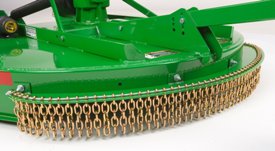 Provides easy maneuvering in tight areas
Provides easy maneuvering in tight areas
The round-back deck design on the RC20 Series Rotary Cutter enables easy maneuvering into tight corners and around trees, fences, and other hard-to-reach areas.
Deck deflectors offered in chain or rubber
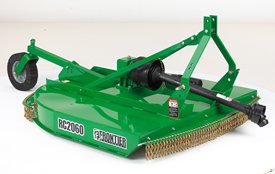 Chain deflector shown
Chain deflector shown
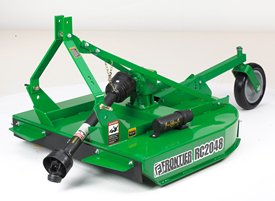 Rubber deflector shown
Rubber deflector shown
The front deck and deflector support are flush with the deck on the RC20 Series Rotary Cutters. This allows water and debris an unrestricted exit off the top of the deck.
These deflectors are available in:
- Rubber or chain on the front
- Metal or chain on the rear
Adjustable cutting height
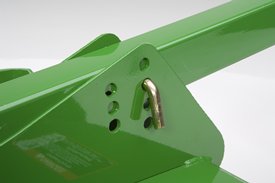 Cutting heights of 3.8 cm to 22.9 cm (1.5 in. to 9 in.)
Cutting heights of 3.8 cm to 22.9 cm (1.5 in. to 9 in.)
Adjusting the cutting height is easy. Along with adjusting a tractor's three-point linkage, simply move the support bar to the desired cutting height.
The RC20 Series Rotary Cutters go as low as 3.8 cm (1.5 in.) or as high as 22.9 cm (9 in.).
Balanced blade pan reduces vibrations
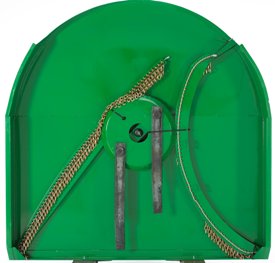 Statically balanced to reduce vibration
Statically balanced to reduce vibration
There is one standard blade pan for all four sizes of the RC20 Series Rotary Cutters. The blade pan is stamped instead of fabricated and is statically balanced to reduce vibration.
The blade bar is thicker for added durability.
Reversible hitch accommodates many types of tractor hookups
 Low hitching point accommodates various tractors
Low hitching point accommodates various tractors
The lower hitching point on the RC20 Series Rotary Cutter accommodates a reversible front hitch for smaller or older tractors.
Lower lip (Z-profile) increases durability and strength
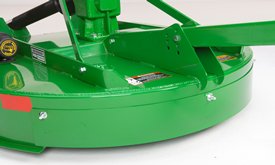 Provides extra strength and durability
Provides extra strength and durability
The RC20 Series Rotary Cutters have a lower lip (Z-profile), which extends from the skid shoes to where the apron opens up. This Z-profile increases the overall durability and strength of the rotary cutter.
Puncture-resistant rear tires
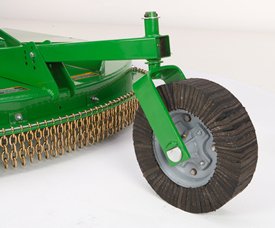 Puncture resistant (laminated shown)
Puncture resistant (laminated shown)
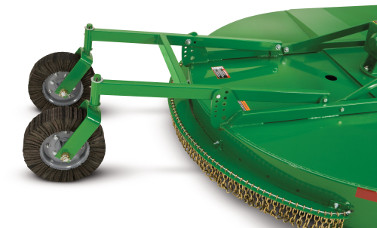
Choose a laminated or solid rubber rear tire for the RC20 Series Rotary Cutter. Both are puncture resistant.
The laminated tire is longer lasting and provides more support when working in sandy or lighter soil conditions.
iMatch™ hitch system provides quick and easy connections
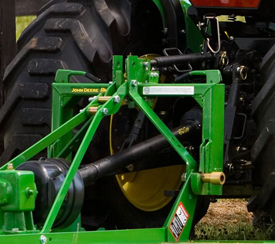 Provides quick and easy connection
Provides quick and easy connection
The iMatch hitch system converts a tractor's 3-point hitch to fixed hooks and attaching points for a super-quick connection (the iMatch hitch is sold separately).
Features
Hagie™ STS16 engine
9.0-L (549-cu in.) Final Tier 4 (FT4) John Deere engine
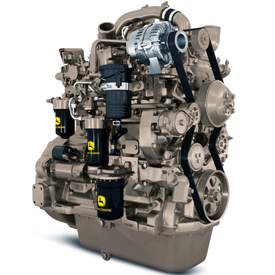 PowerTech™ PSS 9.0-L (549-cu in.) John Deere diesel engine
PowerTech™ PSS 9.0-L (549-cu in.) John Deere diesel engine
The Hagie STS16 Sprayer is powered by the PowerTech PSS 9.0-L (549-cu in.) John Deere diesel engine, which is offered in a 279.6-kW (375-hp) FT4 configuration.
These turbocharged, air-to-air aspirated engines deliver consistent power over a wide range of engine speeds (rpm) with a power bulge rated speed to provide excellent torque in demanding applications.
Engine location
 Rear-mounted engine
Rear-mounted engine
The rear-mounted engine keeps constant weight to offset the spray boom and leaves space in the center of machine for the varying weight of fuel and rinse tanks. This allows for better coolant airflow and reduction of cab noise.
Solution tank, pump, and pump switch
The solution system is a constantly monitored, continuously adjusted, computer-controlled system. The cab-mounted digital spray system console receives information from various inputs to help determine L/ha (gpa) and L/min (gpm).
Solution tank
 Solution tank
Solution tank
| Sprayer model | Tank capacity | Tank type |
| STS10 | 3785 L (1000 gal.) | Stainless-steel tank |
| STS12 | 4542 L (1200 gal.) | Stainless-steel tank |
| STS14 | 5299 L (1400 gal.) | Stainless-steel tank |
| STS16 | 6056 L (1600 gal.) | Stainless-steel tank |
Solution pump
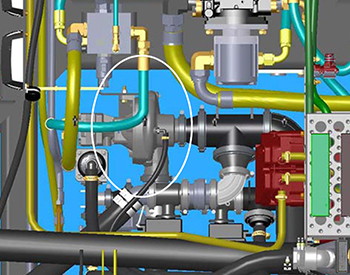 Solution pump
Solution pump
The Hypro® 9306C-HM1C-BU solution pump (located beneath center of machine) is a centrifugal-type, hydraulically-driven pump that is controlled by the solution pump control valve and the spray system console. It comes with silicon-carbide seals, 7.6-cm (3-in.) inlet plumbing and 5.1-cm (2-in.) outlet plumbing.
The solution pump draws solution out of the tank at the rate determined during calibration. It dispenses solution through the many valves and hoses that make up the spray system and also dispenses fluids through the agitation and rinse systems.
Solution pump switch
 Solution pump switch
Solution pump switch
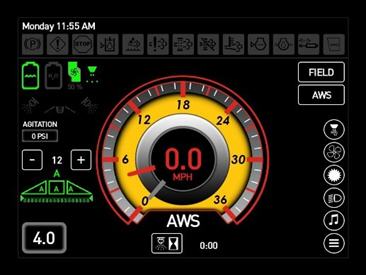 Machine control display - Home
Machine control display - Home
The solution pump switch is located on the side console and is used to turn the solution pump on and off.
NOTE: When the solution pump is on, a solution pump indicator (located on the machine display home page - field mode) will be illuminated.
Hypro is a trademark of Pentair Flow Technologies, LLC.
STS Series spray booms
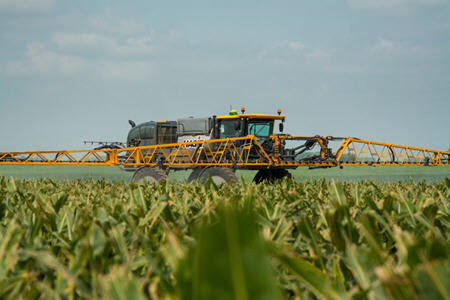 STS Series Sprayer booms
STS Series Sprayer booms
The spray booms are controlled by an electrohydraulic system. This system consists of operator-manipulated switches (located on the side console and the hydrostatic drive control handle) and hydraulic cylinders (attached to the booms), which provide lift, level, and horizontal extension.
The spray booms are offered in a variety of configurations depending on the model and the producer's application needs.
27.4-m (90-ft) boom with 38.1-cm (15-in.) row spacing

Numerical values key:
- Section one
- Section two
- Section three
- Section four
- Section five
- Section six
- Section seven
- Section eight
- Section nine
Alphabetical values key:
- 18.3-m (60-ft) 24-row planter
- 9.1-m (30-ft) 12-row planter
- 9.1-m (30-ft) 12-row planter
- 9.1-m (30-ft) 12-row planter
30.5-m (100-ft) boom with 38.1-cm (15-in.) row spacing

Numerical values key:
- Section one
- Section two
- Section three
- Section four
- Section five
- Section six
- Section seven
- Section eight
- Section nine
Alphabetical values key:
- 18.3-m (60-ft) 24-row planter
- 3.05 m (10 ft)
- 9.1-m (30-ft) 12-row planter
- 9.1-m (30-ft) 12-row planter
- 9.1-m (30-ft) 12-row planter
- 3.05 m (10 ft)
36.6-m (120-ft) boom with 38.1-cm (15-in.) row spacing

Numerical values key:
- Section one
- Section two
- Section three
- Section four
- Section five
- Section six
- Section seven
- Section eight
- Section nine
Alphabetical values key:
- 9.1 m (30 ft)
- 18.3-m (60-ft) 24-row planter
- 9.1 m (30 ft)
- 9.1-m (30-ft) 16-row planter
- 9.1-m (30-ft) 16-row planter
- 9.1-m (30-ft) 16-row planter
- 4.6 m (15 ft)
- 9.1-m (30-ft) 12-row planter
- 9.1-m (30-ft) 12-row planter
- 9.1-m (30-ft) 12-row planter
- 4.6 m (15 ft)
Boom configurations
| STS Series model |
Boom location |
Minimum boom width |
Maximum boom width |
Number of boom sections |
Wet boom nozzle spacing |
| STS10 | Front | 27.4 m/30.5 m |
36.6 m (120 ft) |
Nine | 38 or 51 cm (15 or 20 in.) |
| STS12 | Front | 27.4 m/30.5 m |
36.6 m (120 ft) |
Nine | 38 or 51 cm (15 or 20 in.) |
| STS14 | Front | 27.4 m/30.5 m |
36.6 m (120 ft) |
Nine | 38 or 51 cm (15 or 20 in.) |
| STS16 | Front | 27.4 m/30.5 m |
27.4 or 36.6 m (90 or 120 ft) |
Nine |
38 or 51 cm |
Materials used in boom construction:
- 27.4-m/30.5-m (90-ft/100-ft) booms - steel
- 36.6-m (120-ft) booms - steel/aluminum hybrid
Frame and axles
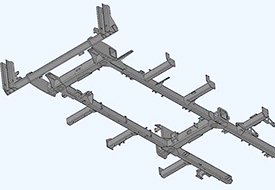 Chassis mainframe
Chassis mainframe
 Horizontal cross-through axle tube
Horizontal cross-through axle tube
The STS Series mainframe design features horizontal cross-through axle tubes, as well as boom and platform mounts on weldment.
- 144.8-cm (57-in.) mainframe width (from outside of each mainframe tube)
- 301-cm (118.5-in.) mainframe width (from outside of each boom cradle weldment)
- 183-cm (72-in.) ground clearance
Features
Hagie™ STS14 engine
9.0-L (549-cu in.) Final Tier 4 (FT4) John Deere engine
 PowerTech™ PSS 9.0-L (549-cu in.) John Deere diesel engine
PowerTech™ PSS 9.0-L (549-cu in.) John Deere diesel engine
The Hagie STS14 is powered by the PowerTech PSS 9.0-L (549-cu in.) John Deere diesel engine, which is offered in a 246-kW (330-hp) FT4 configuration.
These turbocharged, air-to-air aspirated engines deliver consistent power over a wide range of engine speeds (rpm) with a power bulge rated speed to provide excellent torque in demanding applications.
Hagie is a trademark of Hagie Manufacturing Company, LLC and similar to John Deere branded equipment, John Deere will also support Hagie equipment.
Solution tank, pump, and pump switch
The solution system is a constantly monitored, continuously adjusted, computer-controlled system. The cab-mounted digital spray system console receives information from various inputs to help determine L/ha (gpa) and L/min (gpm).
Solution tank
 Solution tank
Solution tank
| Sprayer model | Tank capacity | Tank type |
| STS10 | 3785 L (1000 gal.) | Stainless-steel tank |
| STS12 | 4542 L (1200 gal.) | Stainless-steel tank |
| STS14 | 5299 L (1400 gal.) | Stainless-steel tank |
| STS16 | 6056 L (1600 gal.) | Stainless-steel tank |
Solution pump
 Solution pump
Solution pump
The Hypro® 9306C-HM1C-BU solution pump (located beneath center of machine) is a centrifugal-type, hydraulically-driven pump that is controlled by the solution pump control valve and the spray system console. It comes with silicon-carbide seals, 7.6-cm (3-in.) inlet plumbing and 5.1-cm (2-in.) outlet plumbing.
The solution pump draws solution out of the tank at the rate determined during calibration. It dispenses solution through the many valves and hoses that make up the spray system and also dispenses fluids through the agitation and rinse systems.
Solution pump switch
 Solution pump switch
Solution pump switch
 Machine control display - Home
Machine control display - Home
The solution pump switch is located on the side console and is used to turn the solution pump on and off.
NOTE: When the solution pump is on, a solution pump indicator (located on the machine display home page - field mode) will be illuminated.
Hypro is a trademark of Pentair Flow Technologies, LLC.
STS Series spray booms
 STS Series Sprayer booms
STS Series Sprayer booms
The spray booms are controlled by an electrohydraulic system. This system consists of operator-manipulated switches (located on the side console and the hydrostatic drive control handle) and hydraulic cylinders (attached to the booms), which provide lift, level, and horizontal extension.
The spray booms are offered in a variety of configurations depending on the model and the producer's application needs.
27.4-m (90-ft) boom with 38.1-cm (15-in.) row spacing

Numerical values key:
- Section one
- Section two
- Section three
- Section four
- Section five
- Section six
- Section seven
- Section eight
- Section nine
Alphabetical values key:
- 18.3-m (60-ft) 24-row planter
- 9.1-m (30-ft) 12-row planter
- 9.1-m (30-ft) 12-row planter
- 9.1-m (30-ft) 12-row planter
30.5-m (100-ft) boom with 38.1-cm (15-in.) row spacing

Numerical values key:
- Section one
- Section two
- Section three
- Section four
- Section five
- Section six
- Section seven
- Section eight
- Section nine
Alphabetical values key:
- 18.3-m (60-ft) 24-row planter
- 3.05 m (10 ft)
- 9.1-m (30-ft) 12-row planter
- 9.1-m (30-ft) 12-row planter
- 9.1-m (30-ft) 12-row planter
- 3.05 m (10 ft)
36.6-m (120-ft) boom with 38.1-cm (15-in.) row spacing

Numerical values key:
- Section one
- Section two
- Section three
- Section four
- Section five
- Section six
- Section seven
- Section eight
- Section nine
Alphabetical values key:
- 9.1 m (30 ft)
- 18.3-m (60-ft) 24-row planter
- 9.1 m (30 ft)
- 9.1-m (30-ft) 16-row planter
- 9.1-m (30-ft) 16-row planter
- 9.1-m (30-ft) 16-row planter
- 4.6 m (15 ft)
- 9.1-m (30-ft) 12-row planter
- 9.1-m (30-ft) 12-row planter
- 9.1-m (30-ft) 12-row planter
- 4.6 m (15 ft)
Boom configurations
| STS Series model |
Boom location |
Minimum boom width |
Maximum boom width |
Number of boom sections |
Wet boom nozzle spacing |
| STS10 | Front | 27.4 m/30.5 m |
36.6 m (120 ft) |
Nine | 38 or 51 cm (15 or 20 in.) |
| STS12 | Front | 27.4 m/30.5 m |
36.6 m (120 ft) |
Nine | 38 or 51 cm (15 or 20 in.) |
| STS14 | Front | 27.4 m/30.5 m |
36.6 m (120 ft) |
Nine | 38 or 51 cm (15 or 20 in.) |
| STS16 | Front | 27.4 m/30.5 m |
27.4 or 36.6 m (90 or 120 ft) |
Nine |
38 or 51 cm |
Materials used in boom construction:
- 27.4-m/30.5-m (90-ft/100-ft) booms - steel
- 36.6-m (120-ft) booms - steel/aluminum hybrid
Frame and axles
 Chassis mainframe
Chassis mainframe
 Horizontal cross-through axle tube
Horizontal cross-through axle tube
The STS Series mainframe design features horizontal cross-through axle tubes, as well as boom and platform mounts on weldment.
- 144.8-cm (57-in.) mainframe width (from outside of each mainframe tube)
- 301-cm (118.5-in.) mainframe width (from outside of each boom cradle weldment)
- 183-cm (72-in.) ground clearance
Features
Hagie™ STS Series engines
John Deere PowerTech™ PSS 6.8-L (415-cu in.) engine
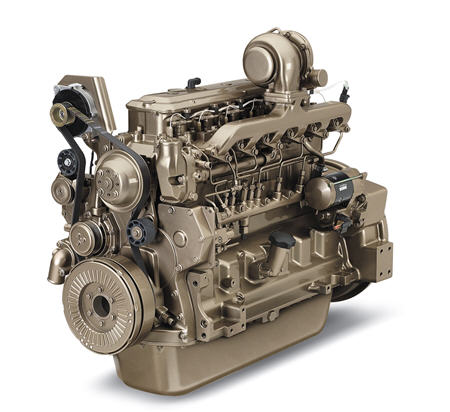 PowerTech™ PSS 6.8L (415-cu in.) engine
PowerTech™ PSS 6.8L (415-cu in.) engine
Beginning with model year 2019, the Hagie STS10 and STS12 Sprayers utilize the John Deere PowerTech 6.8L (415-cu in.) diesel engine. This engine offers 208.8 kW (280 hp) with a peak power of 223.7 kW (300 hp) in the STS10 and 223.7 kW (300 hp) in the STS12. The reliable performance of these engines couple well with the drive system on the STS Sprayers to provide the operator excellent power on demand.
Engine location
 Rear-mounted engine
Rear-mounted engine
The rear-mounted engine keeps constant weight to offset the spray boom and leaves space in the center of machine for the varying weight of fuel and rinse tanks. This allows for better coolant airflow and reduction of cab noise.
Hagie is a trademark of Hagie Manufacturing Company, LLC and similar to John Deere branded equipment, John Deere will also support Hagie equipment.
Solution tank, pump, and pump switch
The solution system is a constantly monitored, continuously adjusted, computer-controlled system. The cab-mounted digital spray system console receives information from various inputs to help determine L/ha (gpa) and L/min (gpm).
Solution tank
 Solution tank
Solution tank
| Sprayer model | Tank capacity | Tank type |
| STS10 | 3785 L (1000 gal.) | Stainless-steel tank |
| STS12 | 4542 L (1200 gal.) | Stainless-steel tank |
| STS14 | 5299 L (1400 gal.) | Stainless-steel tank |
| STS16 | 6056 L (1600 gal.) | Stainless-steel tank |
Solution pump
 Solution pump
Solution pump
The Hypro® 9306C-HM1C-BU solution pump (located beneath center of machine) is a centrifugal-type, hydraulically-driven pump that is controlled by the solution pump control valve and the spray system console. It comes with silicon-carbide seals, 7.6-cm (3-in.) inlet plumbing and 5.1-cm (2-in.) outlet plumbing.
The solution pump draws solution out of the tank at the rate determined during calibration. It dispenses solution through the many valves and hoses that make up the spray system and also dispenses fluids through the agitation and rinse systems.
Solution pump switch
 Solution pump switch
Solution pump switch
 Machine control display - Home
Machine control display - Home
The solution pump switch is located on the side console and is used to turn the solution pump on and off.
NOTE: When the solution pump is on, a solution pump indicator (located on the machine display home page - field mode) will be illuminated.
Hypro is a trademark of Pentair Flow Technologies, LLC.
STS Series spray booms
 STS Series Sprayer booms
STS Series Sprayer booms
The spray booms are controlled by an electrohydraulic system. This system consists of operator-manipulated switches (located on the side console and the hydrostatic drive control handle) and hydraulic cylinders (attached to the booms), which provide lift, level, and horizontal extension.
The spray booms are offered in a variety of configurations depending on the model and the producer's application needs.
27.4-m (90-ft) boom with 38.1-cm (15-in.) row spacing

Numerical values key:
- Section one
- Section two
- Section three
- Section four
- Section five
- Section six
- Section seven
- Section eight
- Section nine
Alphabetical values key:
- 18.3-m (60-ft) 24-row planter
- 9.1-m (30-ft) 12-row planter
- 9.1-m (30-ft) 12-row planter
- 9.1-m (30-ft) 12-row planter
30.5-m (100-ft) boom with 38.1-cm (15-in.) row spacing

Numerical values key:
- Section one
- Section two
- Section three
- Section four
- Section five
- Section six
- Section seven
- Section eight
- Section nine
Alphabetical values key:
- 18.3-m (60-ft) 24-row planter
- 3.05 m (10 ft)
- 9.1-m (30-ft) 12-row planter
- 9.1-m (30-ft) 12-row planter
- 9.1-m (30-ft) 12-row planter
- 3.05 m (10 ft)
36.6-m (120-ft) boom with 38.1-cm (15-in.) row spacing

Numerical values key:
- Section one
- Section two
- Section three
- Section four
- Section five
- Section six
- Section seven
- Section eight
- Section nine
Alphabetical values key:
- 9.1 m (30 ft)
- 18.3-m (60-ft) 24-row planter
- 9.1 m (30 ft)
- 9.1-m (30-ft) 16-row planter
- 9.1-m (30-ft) 16-row planter
- 9.1-m (30-ft) 16-row planter
- 4.6 m (15 ft)
- 9.1-m (30-ft) 12-row planter
- 9.1-m (30-ft) 12-row planter
- 9.1-m (30-ft) 12-row planter
- 4.6 m (15 ft)
Boom configurations
| STS Series model |
Boom location |
Minimum boom width |
Maximum boom width |
Number of boom sections |
Wet boom nozzle spacing |
| STS10 | Front | 27.4 m/30.5 m |
36.6 m (120 ft) |
Nine | 38 or 51 cm (15 or 20 in.) |
| STS12 | Front | 27.4 m/30.5 m |
36.6 m (120 ft) |
Nine | 38 or 51 cm (15 or 20 in.) |
| STS14 | Front | 27.4 m/30.5 m |
36.6 m (120 ft) |
Nine | 38 or 51 cm (15 or 20 in.) |
| STS16 | Front | 27.4 m/30.5 m |
27.4 or 36.6 m (90 or 120 ft) |
Nine |
38 or 51 cm |
Materials used in boom construction:
- 27.4-m/30.5-m (90-ft/100-ft) booms - steel
- 36.6-m (120-ft) booms - steel/aluminum hybrid
Frame and axles
 Chassis mainframe
Chassis mainframe
 Horizontal cross-through axle tube
Horizontal cross-through axle tube
The STS Series mainframe design features horizontal cross-through axle tubes, as well as boom and platform mounts on weldment.
- 144.8-cm (57-in.) mainframe width (from outside of each mainframe tube)
- 301-cm (118.5-in.) mainframe width (from outside of each boom cradle weldment)
- 183-cm (72-in.) ground clearance
Agitator performance for the STS12 Sprayer
 See corresponding letter descriptions below
See corresponding letter descriptions below
Agitator performance chart key:
- A - flow (gpm)
- B - agitation pressure (psi)
- C - input flow (gpm)
- D - output flow (gpm)
- E - recommended flow for wettable powder mixes
Model year 2019 Montag® Fortifier 2212 Cover Crop System for Hagie™ STS Sprayers
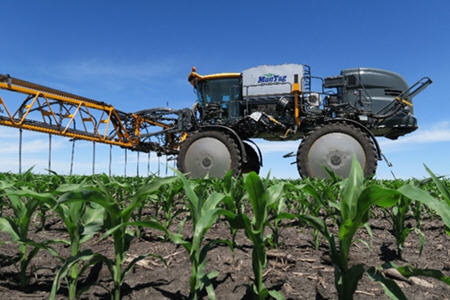 Montag cover crop system
Montag cover crop system
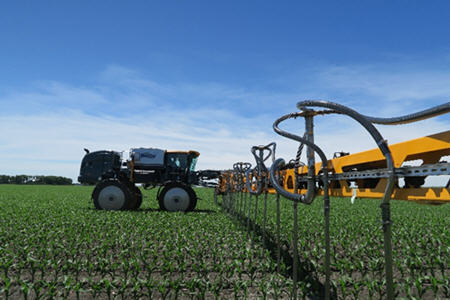 Montag cover crop system
Montag cover crop system
Boost the versatility of the Hagie STS Sprayers and optimize soil health with a cover crop seeding solution. The Montag Fortifier 2212 Cover Crop System is an engineered solution specifically designed to be compatible with model year 2014 and newer Hagie STS12 Sprayers equipped with a 36.6-m (120-ft) hybrid boom.
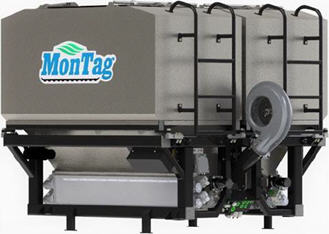
The Montag cover crop system features a two-bin design totaling 4.4-m3 (155-cu ft) capacity, offering the highest cover bin capacity available on the market to improve uptime. The stainless-steel twin bin design equips producers with two-product application proficiency.
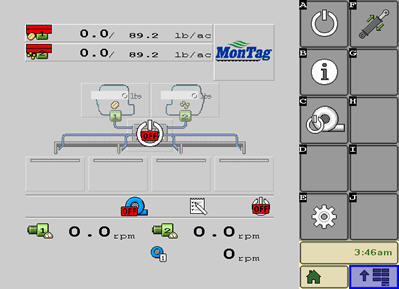 Montag cover crop system controls
Montag cover crop system controls
The unit comes standard with a Montag-developed ISOBUS rate controller and ISOBUS scales for optimal application accuracy. Operating on the standard Hagie hydraulic pump and offered with standard four-section control, metering augers ensure the highest possible row-to-row accuracy. Producers are also provided with the STS12 chassis hardware package to ensure system adaptability with the kit.
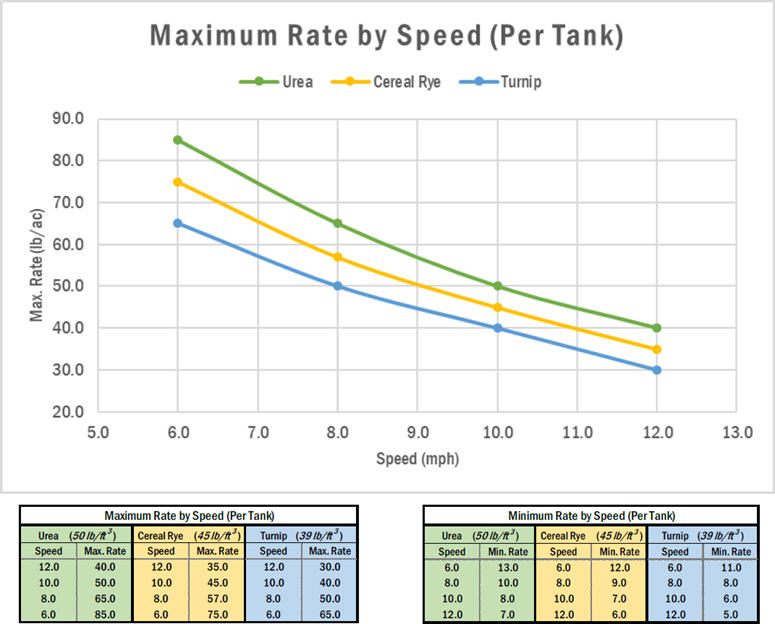 Maximum rate by speed per tank
Maximum rate by speed per tank
When performing seeding applications at 16.1 km/h (10 mph), producers have the ability to apply 7.3 kg to 40.8 kg (16 lb to 90 lb) of seed per acre to meet individual productivity needs. The only system offered today specifically designed for this purpose, the Montag Fortifier 2212 Cover Crop System provides a unique solution to protect and nurture soil health while enhancing versatility, making the Hagie STS a one-machine solution for full season application needs.
| Key specifications | |
| Rows | 12 rows (12 rows split to 48 rows [49 drops]) |
| Sections | Four sections |
| Product capacity | |
| Bin | 2,192 L (77.4 cu ft), 1,760 kg (1.94 tons) |
| Total | 4,383 L (154.8 cu ft), 3,511 kg (3.87 tons) |
| Rate capacity | |
| Bin | 9-56 kg/ha (8-50 lb/acre) |
| Total | 18-101 kg/ha (16-90 lb/acre) |
| Weight | 1,474 kg (3,250 lb) |
| Overall height | 193.8 cm (76.3 in.) |
| Overall length | 246.4 cm (97 in.) |
| Overall width | 212.1 cm (83.5 in.) |
| Product fill height | 374.1 cm (147.3 in.) |
| Product fill inlet size | 0.61 m2 (6.55 sq ft) |
| Meter outlet | 5.08 cm (2 in.) |
| Boom drop | 3.18 cm (1.25 in.) |
| Required hydraulic capacity | 95 L/min (25 gpm) |
| Required hydraulic pressure | 203 bar (2,950 psi) |
NOTE: Compatible with model year 2014 and newer Hagie STS12 with 36.6-m (120-ft) hybrid boom.
Montag Mfg. has an allied partnership agreement with John Deere as it relates to the cover crop system and is responsible for providing sales and technical support to dealers. For additional information about the system, visit www.montagmfg.com or call 712-852-4572.
Montag is a trademark of Montag Manufacturing, Inc. Hagie is a trademark of Hagie Manufacturing Company, LLC and similar to John Deere branded equipment, John Deere will support Hagie equipment.
Features
Hagie™ STS Series engines
John Deere PowerTech™ PSS 6.8-L (415-cu in.) engine
 PowerTech™ PSS 6.8L (415-cu in.) engine
PowerTech™ PSS 6.8L (415-cu in.) engine
Beginning with model year 2019, the Hagie STS10 and STS12 Sprayers utilize the John Deere PowerTech 6.8L (415-cu in.) diesel engine. This engine offers 208.8 kW (280 hp) with a peak power of 223.7 kW (300 hp) in the STS10 and 223.7 kW (300 hp) in the STS12. The reliable performance of these engines couple well with the drive system on the STS Sprayers to provide the operator excellent power on demand.
Engine location
 Rear-mounted engine
Rear-mounted engine
The rear-mounted engine keeps constant weight to offset the spray boom and leaves space in the center of machine for the varying weight of fuel and rinse tanks. This allows for better coolant airflow and reduction of cab noise.
Hagie is a trademark of Hagie Manufacturing Company, LLC and similar to John Deere branded equipment, John Deere will also support Hagie equipment.
Solution tank, pump, and pump switch
The solution system is a constantly monitored, continuously adjusted, computer-controlled system. The cab-mounted digital spray system console receives information from various inputs to help determine L/ha (gpa) and L/min (gpm).
Solution tank
 Solution tank
Solution tank
| Sprayer model | Tank capacity | Tank type |
| STS10 | 3785 L (1000 gal.) | Stainless-steel tank |
| STS12 | 4542 L (1200 gal.) | Stainless-steel tank |
| STS14 | 5299 L (1400 gal.) | Stainless-steel tank |
| STS16 | 6056 L (1600 gal.) | Stainless-steel tank |
Solution pump
 Solution pump
Solution pump
The Hypro® 9306C-HM1C-BU solution pump (located beneath center of machine) is a centrifugal-type, hydraulically-driven pump that is controlled by the solution pump control valve and the spray system console. It comes with silicon-carbide seals, 7.6-cm (3-in.) inlet plumbing and 5.1-cm (2-in.) outlet plumbing.
The solution pump draws solution out of the tank at the rate determined during calibration. It dispenses solution through the many valves and hoses that make up the spray system and also dispenses fluids through the agitation and rinse systems.
Solution pump switch
 Solution pump switch
Solution pump switch
 Machine control display - Home
Machine control display - Home
The solution pump switch is located on the side console and is used to turn the solution pump on and off.
NOTE: When the solution pump is on, a solution pump indicator (located on the machine display home page - field mode) will be illuminated.
Hypro is a trademark of Pentair Flow Technologies, LLC.
STS Series spray booms
 STS Series Sprayer booms
STS Series Sprayer booms
The spray booms are controlled by an electrohydraulic system. This system consists of operator-manipulated switches (located on the side console and the hydrostatic drive control handle) and hydraulic cylinders (attached to the booms), which provide lift, level, and horizontal extension.
The spray booms are offered in a variety of configurations depending on the model and the producer's application needs.
27.4-m (90-ft) boom with 38.1-cm (15-in.) row spacing

Numerical values key:
- Section one
- Section two
- Section three
- Section four
- Section five
- Section six
- Section seven
- Section eight
- Section nine
Alphabetical values key:
- 18.3-m (60-ft) 24-row planter
- 9.1-m (30-ft) 12-row planter
- 9.1-m (30-ft) 12-row planter
- 9.1-m (30-ft) 12-row planter
30.5-m (100-ft) boom with 38.1-cm (15-in.) row spacing

Numerical values key:
- Section one
- Section two
- Section three
- Section four
- Section five
- Section six
- Section seven
- Section eight
- Section nine
Alphabetical values key:
- 18.3-m (60-ft) 24-row planter
- 3.05 m (10 ft)
- 9.1-m (30-ft) 12-row planter
- 9.1-m (30-ft) 12-row planter
- 9.1-m (30-ft) 12-row planter
- 3.05 m (10 ft)
36.6-m (120-ft) boom with 38.1-cm (15-in.) row spacing

Numerical values key:
- Section one
- Section two
- Section three
- Section four
- Section five
- Section six
- Section seven
- Section eight
- Section nine
Alphabetical values key:
- 9.1 m (30 ft)
- 18.3-m (60-ft) 24-row planter
- 9.1 m (30 ft)
- 9.1-m (30-ft) 16-row planter
- 9.1-m (30-ft) 16-row planter
- 9.1-m (30-ft) 16-row planter
- 4.6 m (15 ft)
- 9.1-m (30-ft) 12-row planter
- 9.1-m (30-ft) 12-row planter
- 9.1-m (30-ft) 12-row planter
- 4.6 m (15 ft)
Boom configurations
| STS Series model |
Boom location |
Minimum boom width |
Maximum boom width |
Number of boom sections |
Wet boom nozzle spacing |
| STS10 | Front | 27.4 m/30.5 m |
36.6 m (120 ft) |
Nine | 38 or 51 cm (15 or 20 in.) |
| STS12 | Front | 27.4 m/30.5 m |
36.6 m (120 ft) |
Nine | 38 or 51 cm (15 or 20 in.) |
| STS14 | Front | 27.4 m/30.5 m |
36.6 m (120 ft) |
Nine | 38 or 51 cm (15 or 20 in.) |
| STS16 | Front | 27.4 m/30.5 m |
27.4 or 36.6 m (90 or 120 ft) |
Nine |
38 or 51 cm |
Materials used in boom construction:
- 27.4-m/30.5-m (90-ft/100-ft) booms - steel
- 36.6-m (120-ft) booms - steel/aluminum hybrid
Frame and axles
 Chassis mainframe
Chassis mainframe
 Horizontal cross-through axle tube
Horizontal cross-through axle tube
The STS Series mainframe design features horizontal cross-through axle tubes, as well as boom and platform mounts on weldment.
- 144.8-cm (57-in.) mainframe width (from outside of each mainframe tube)
- 301-cm (118.5-in.) mainframe width (from outside of each boom cradle weldment)
- 183-cm (72-in.) ground clearance
Features
Hagie™ DTS Series engines
6.7-L (408.9-cu in.) Cummins® QSB engine
 Final Tier 4 (FT4) diesel engine
Final Tier 4 (FT4) diesel engine
The Hagie DTS10 is powered by a 6.7-L (408.9-cu in.) Cummins QSB diesel engine providing 165-kW (225-hp) using an emissions-compliant Final Tier 4 (FT4) configuration. This 6.7-L (408.9-cu in.) engine is electronic with an air-to-air cooler and turbocharger.
The FT4 engine requires ultra-low sulfur diesel (ULSD).
Engine location
 Engine location
Engine location
The rear-mounted engine keeps constant weight to offset the spray boom and leaves space in the center of machine for the varying weight of fuel and rinse tanks. This allows for better coolant airflow and reduction of cab noise.
Engine exhaust
 Engine exhaust stack
Engine exhaust stack
The engine exhaust is located at the rear of the machine. This helps to reduce interior cab and noise vibration.
Cummins is a trademark of Cummins, Inc. Hagie is a trademark of Hagie Manufacturing Company, LLC and similar to John Deere branded equipment, Deere will also support Hagie equipment.
DTS10 cab and controls overview
Front console
 Front console steering
Front console steering
 Front console telescope
Front console telescope
 Front console tilt
Front console tilt
 Front console foot controls
Front console foot controls
| Location (image) | Component | Description/notes |
| A | Steering wheel | Optional premium leather-wrapped steering wheel |
| B | Hazard/warning lights switch | --- |
| C | Highway/warning lights switch | --- |
| D | Turn signal indicator | Left-hand side |
| E | Highway running lights indicator | --- |
| F | High beams indicator | --- |
| G | Turn signal indicator | Right-hand side |
| H | Steering wheel telescope adjust handle | Available only if equipped with this option |
| I | Steering column tilt adjust button | Knee angle Available only if equipped with this option |
| J | Steering column release pedal | --- |
| K | Operator foot pegs | Two pegs Available only if equipped with this option |
| L | Deceleration (decel) pedal | --- |
| M | Horn | --- |
| N | Windshield washer | --- |
| O | Turn signal lever | --- |
| P | Windshield wiper speed | --- |
| Q | High beams (brights) | --- |
Side console







| Location (image) | Component | Description/notes |
| A | Emergency stop (e-stop) switch | The e-stop switch provides a quick method for stopping the engine in an emergency situation. |
| B | Foam marker switch (if equipped) | The foam marker switch controls foam application on both sides of the machine. |
| C | Rinse switch | The rinse switch is used to rinse the solution tank and spray booms. |
| D | Boom solution valve switches | The boom solution valve switches each control a valve located on the boom or transom. The valves control the flow of the solution through the boom. |
| E | Fence row switch (left-hand side) | The fence row switches are used in the selection of either the right or left fence row spray nozzle. |
| F | Rate control switches | The rate control switches control the rate in which solution is applied through the spray booms by either the rate controller (enable) or operator-controlled spray rate (manual). |
| G | Rear nozzle switch | The rear nozzle switch controls the two rear nozzles (located behind the rear tires). |
| H | Pump speed and rate switches | The pump speed/rate switches allow the operator to increase or decrease flow rate through the spray system. |
| I | Fence row switch (right-hand side) | --- |
| J | Main tank valve switch (left-hand side) | The main tank valve switch controls the solution tank valve. This switch must be in the on (open) position for spray application. |
| K | Solution pump switch | The solution pump switch is used to turn the solution pump on or off. |
| L | Agitation valve switch | The agitation valve switch controls the rate of flow through the agitation system. |
| M | Main tank valve switch (right-hand side | --- |
| N | Boom extension switches (left/right outer fold) | The boom extension switches are used to extend or retract the outer boom extensions. |
| O | Traction valve switch | --- |
| P | Ignition switch | --- |
| Q | Power mirror switch (if equipped) | The power mirror switch allows vertical or horizontal adjustment of the electric side-view mirrors by pressing the switch in the desired position. |
| R | Hydrostatic drive control handle | The hydrostatic drive control handle controls the direction of the machine and the speed in which it travels. It is also used to control the spray booms, master spray, end row management, and shift up/down speeds. |
| S | Transom switch (up/down) | The transom switch is used to raise and lower the main lift. |
| T | Right-hand boom switch | The left- and right-hand boom switches are used to raise, lower, extend, and retract the spray booms. |
| U | Left-hand boom switch | The left- and right-hand boom switches are used to raise, lower, extend, and retract the spray booms. |
| V | Master spray switch | The master spray switch activates the boom solution valves. |
| W | End row management switch | The end-row management switch is a programmable switch that enables various functions (i.e. all-wheel steer, auto steer, master spray, and NORAC® enable) when the switch is depressed. End-row management settings are programmed through the machine display. |
| X | Shift up switch | The shift up/down switches are used for speed range selection. |
| Y | Shift down switch | The shift up/down switches are used for speed range selection. |
| Z | Parking brake switch | The parking brake switch is used to engage and disengage the parking brake, as well as extend and retract the ladder. |
| AA | Throttle switch | The throttle switch is used to control engine speed (rpm). |
| BB | Remote stereo controls | The remote stereo controls are conveniently located to control the stereo (volume, mute, source, and seek). |
| CC | 12-V power ports | Four power ports are provided for the connection of additional items (such as radios and computer equipment). |
| DD | Two auxiliary audio input connections | The auxiliary audio input allows connection of a personal iPod® device or MP3 player. |
Overhead monitors and controls






| Location (image) | Component | Description/notes |
| A | Courtesy/interior work light | The courtesy light comes on automatically when the cab door is opened. The interior work light is activated by manually pressing the interior work light switch (located on the light housing). |
| B | Stereo (if equipped) | The stereo features with an AM/FM tuner, weatherband broadcasting, CD player, MP3 player, USB/iPod controls, and Bluetooth® wireless system (if equipped). |
| C | Climate controls | The climate controls allow the operator to set and maintain desired cab temperature. Vents are placed throughout the cab to keep air circulating and to maintain clear windows throughout the cab. |
| D | NORAC monitor (if equipped) | The NORAC monitor controls the automatic boom leveling system. |
| E | Spray system console | The spray system is controlled by the spray system console and the solution pump control valve. The system receives data and automatically makes adjustments based on the target rate of application set by the operator. |
| F | Machine display | The machine display is the central control center of the machine. It controls many of the machine’s electronically driven functions (i.e. machine drive, AWS, attachment operation, tread adjustment, spray systems, lights, diagnostics, etc.). |
| G | Machine gauges | The machine gauge panel on the A-post is conveniently located for viewing engine rpm, fuel level, engine coolant temperature, and engine aftertreatment level (if equipped). |
NORAC is a trademark of NORAC Systems International, Inc. iPod is a trademark of Apple, Inc. Bluetooth is a trademark of Bluetooth SIG, Inc.
Solution tank, pump, and pump switch
Solution tank
 Solution tank
Solution tank
 Solution tank drain grade
Solution tank drain grade
Two 1892-L (500-gal.) polyethylene tanks are mounted on tank cradles on each side of the machine. The solution tank design allows the sump to drain on a 30 percent grade and is equipped with a spinball rinse system. A mechanical sight gauge is located on top of each solution tank to visually check the solution level at all times.
Solution pump
 Solution pump
Solution pump
The Hypro® 9306C-HM1C solution pump (located beneath the center of the machine) is a centrifugal-type hydraulically driven pump that is controlled by the solution pump control valve and the spray system console. It comes with silicon-carbide seals.
The solution pump draws solution out of the tank at the rate determined during calibration. It dispenses solution through the many valves and hoses that make up the spray system and also dispenses fluids through the agitation and rinse systems.
Solution pump switch
 Solution pump switch
Solution pump switch
 Solution pump indicator
Solution pump indicator
The solution pump switch is located on the side console and is used to turn the solution pump on and off.
NOTE: When the solution pump is on, a solution pump indicator (located on the machine display home page - field mode) will illuminate.
Hypro is a trademark of Pentair Flow Technologies, LLC.
DTS10 spray booms
 Wet boom
Wet boom
The spray booms are controlled by an electrohydraulic system. This system consists of operator-manipulated switches (located on the side console and the hydrostatic drive control handle) and hydraulic cylinders (attached to the booms), which provide lift, level, and horizontal extension.
Hydraulically folding the extensions of an 18.3- or 24.4-m (60- or 80-ft) or 18.3- or 27.4-m (60- or 90-ft) spray boom and shutting off the outer sections essentially turns it into an 18.3-m (60-ft) spray boom. The wet boom connections feature with ARAG® EasyFit fittings with an o-ring seal and are 13-mm (0.5-in.) schedule 5 pipe-fed from one end with a 25-mm (1-in.) hose.
 Boom connections
Boom connections
Boom configurations
| Sprayer model |
Boom location |
Minimum boom width |
Maximum boom width |
Number of boom sections |
Wet boom nozzle spacing |
| DTS10 | Front | 18.3 or 24.4 m (60 or 80 ft) |
18.3 or 27.4 m (60 or 90 ft) |
Seven | Standard - 38 cm (15 in.) Optional - 51 cm (20 in.) |
ARAG is a trademark of ARAG S.r.l.
Frame and axles
 Chassis mainframe
Chassis mainframe
 Horizontal cross-through axle tube
Horizontal cross-through axle tube
The DTS10 Sprayer mainframe design features horizontal cross-through axle tubes, as well as boom and platform mounts on weldment.
- 360.7-cm (142-in.) mainframe width
- 182.9-cm (72-in.) ground clearance
Features
CommandDrive™ powertrain delivers improved efficiency with Auto Mode
 Experience fuel saving and noise reduction with CommandDrive
Experience fuel saving and noise reduction with CommandDrive
Spray more acres per day at a lower cost of operation with the CommandDrive powertrain. You will see an improved system response to maintain consistent application and transport speeds in challenging conditions, while reducing overall fuel consumption and cab noise.
The CommandDrive powertrain comes in base on all R4060 and R4045 Sprayers. This powertrain has the following features:
- Auto Mode dynamically commands engine speed depending on load requirements
- Reduce engine speed and save up to 20 percent on fuel consumption
- 3- to 5-decibel reduction in noise for long hours in the cab
- Single pump flow instead of two
- Improved traction control
Operator controls within easy reach in CommandView™ III cab with integrated GreenStar™ 4600 CommandCenter™ display
 4 Series Sprayer operator station
4 Series Sprayer operator station
When operators first enter the Command View III cab, they will notice that significant changes have been made. Key sprayer controls are more easily accessible to the operator on the redesigned CommandARM™ control panel and the multifunction handle has a more ergonomic fit and feel.
The multifunction handle has six reconfigurable buttons, a scroll to select speed range, and allows operators to better manage their headlands with the Headland Management System (HMS™) button. To finish out the upgrades, the GreenStar™ display has been upgraded to a faster, more user-friendly 4600 CommandCenter™ display, which allows operators to efficiently capture, manage, and transfer data.
Comfort continues to be enhanced by the ComfortCommand™ seat, which offers both fore-aft and lateral attenuation along with 15 degrees of right-hand seat swivel on all cab options. For first-class comfort, the premium cab offers a heated/ventilated leather seat and light-emitting diode (LED) cab lights.
The 4 Series Sprayers are JDLink™ telematics system capable, which enable features such as John Deere Wireless Data Transfer (WDT), Service ADVISOR™ Remote diagnostics, and Remote Display Access (RDA). These integrated solutions enable additional uptime and reduce cost of operation. All of the CommandView III cab features allow operators to run longer hours, increasing the ability to get more acres sprayed in a day.
Steel and carbon-fiber booms feature swing-link suspension for optimum stability
Make fewer passes through the field and reduce compaction, as well as time spent spraying, with John Deere booms.
All John Deere booms are more stable due to the swing link suspension, which helps translate rough areas in the field into horizontal (side-to-side) movement of the boom rather than lateral (up and down) movement. This additional stability means increased productivity as the boom now has the ability to more accurately maintain spray height above the crop, delivering a precise spray pattern. The swing link suspension also translates into uptime as the additional stability means less crop damage, resulting in less mechanical boom damage.
The enhanced design allows the boom to unfold and fold faster, getting the operators into the field quicker, and the flat fold design delivers superior transport visibility.
Automate tasks from filling station with Solution Command System
 Solution Command offer push button loading
Solution Command offer push button loading
 12-button keypad and micro-display
12-button keypad and micro-display
4 Series Sprayers are available with the SCS and have been completely redesigned to allow quick and easy operation at the load station for all operator skill levels. The optional system allows complete automation at the load station with a 12-button keypad. The features include the following:
- Fill station light on/off
- Pump on/off
- Agitation
- Pump speed increase
- Pump speed decrease
- Eductor on/off
- Master on/off
- Automated rinse cycle
- Visual nozzle check
- Pull-on fill
- Push-on fill
- Target fill
The system also features a micro-display, providing real-time feedback on the system operations, as well as ability to select a rinse method and the ability to monitor progress during the automated rinse function. Overall, the enhanced Solution Command System increases operational performance by increasing ease of use through automation at the load station.
Load Command™ enables fastest loading speeds for maximum efficiency
 Quick loading with the Load Command system
Quick loading with the Load Command system
Load at speeds as fast as 1500 L/min (400 gpm) with the fully integrated Load Command system available for John Deere’s largest sprayer models. This highly efficient loading time allows for more spraying time or more acres per day while complementing the machine’s three-season asset-utilization value.
How it works
Load Command allows the operator to pull the sprayer up to the tender unit, couple the Load Command tender arm to the Load Command coupler on the sprayer, and receive a full 4542-L (1200-gal.) load in as fast as 3 minutes and a full 6057-L (1600-gal.) load in 4 minutes.
| Model | Tank size | Load time |
| R4045 | 4542 L (1200 gal.) | 3 minutes |
| R4060 | 6057 L (1600 gal.) | 4 minutes |
Load Command dramatically reduces the fill time and the amount of operator interface time. When the system completes loading, the couplers automatically disengage from each other. This allows the operator to remain in the cab with the ability to quickly return to spraying.
By providing improved loading times, the John Deere R4045 and R4060 Sprayers with Load Command are more versatile, more productive, and will provide a better overall return on investment.
With the ability to create more spraying time, the Load Command system enables a custom applicator to achieve more value by applying products more efficiently and, in turn, generating more revenue per season.
Compatibility
Load Command can be ordered from the factory for R4045 and R4060 Sprayer models equipped with Auto Fill. Load Command is also available as a performance upgrade kit for existing 4930, 4940, R4045, and R4060 Sprayers.
NOTE: Load Command and Front Fill are not compatible to be installed on the machine at the same time.
Direct injection system expands carrying capacity for raw chemicals
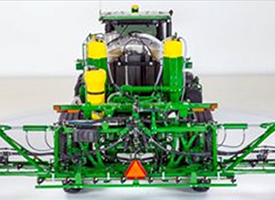 Field-installed 511-L (135-gal.) direct-injection system
Field-installed 511-L (135-gal.) direct-injection system
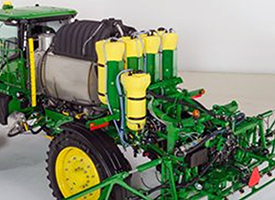 Field-installed 889-L (235-gal.) direct-injection system
Field-installed 889-L (235-gal.) direct-injection system
As solution tank mixes become more complex, operators need a better way to manage the products they are mixing in helping to reduce the risk of chemical residue. The integrated direct-injection system provides an additional carrying capacity for raw chemicals and allows injection of single, dual, or triple products directly into the boom depending on installed configuration.
| Machine | Direct injection carrying capacity |
Injection capability |
| R4030/R4038 model year 2015 and older (serial number 10,999 and lower) |
511 L (135 gal.) | Inject up to two chemicals (one high volume, one low volume) |
| R4030/R4038 model year 2016 and newer (serial number 11,000 and higher) |
889 L (235 gal.) | Inject up to three chemicals (two high volume, one low volume) |
| R4045 | 889 L (235 gal.) | Inject up to three chemicals (two high volume, one low volume) |
NOTE: Low-volume tanks and pumps must be configured with at least one high-volume tank and pump. High-volume tank and pump can be configured by itself.
Direct injection helps provide quicker changeovers and faster cleanouts while also helping to minimize the risk of using multiple chemicals. This is accomplished by allowing operators the ability to isolate higher-residual-risk chemicals in the injection system while mixing lower-risk chemicals in the solution tank.
The minimum and maximum application rates for each pump are as follows:
| Direct injection pump system | High-rate pump | Low-rate pump |
| Application rate range (minimum to maximum) |
148-5900 mL/min (5-200 oz/min) | 29.6-1183 mL/min (1-40 oz/min) |
| Agitation capability | Not available – suspension products not recommended | Not available – suspension products not recommended |
NOTE: See Operator’s Manual for additional details based on boom size and speed range, and refer to Tools/Direct Inject Calculator within the ApplyPlus™ mobile app (download via Apple® App Store® or Google Play™ store).
Apple and App Store are trademarks of Apple Inc. Google Play is a trademark of Google LLC.
ExactApply™ nozzle control delivers precise application with up to 20 acres per hour of added productivity
 Turn compensation mode
Turn compensation mode
 Individual nozzle control mode
Individual nozzle control mode
John Deere’s intelligent nozzle control system ExactApply helps producers better manage drift and deliver a precise application. By maintaining target rate and pressure over a wider speed range, ExactApply can improve productivity up to 20 acres per hour*.
*NOTE: Assumes a 3.2-km/h (2-mph) average operating speed increase.
ExactApply is offered as a factory-installed option as well as a performance upgrade kit that can be added to existing 4 Series Sprayer models.
How it works
The ExactApply system features multiple modes of operation including pulse-width modulation (PWM) and individual nozzle control:
- 15-Hz PWM pulses one solenoid to achieve a consistent droplet size and maintain spray pressure throughout a wider range of speeds and application rates.
- 30-Hz PWM (combined mode) pulses both solenoids in the ExactApply nozzle body at 15 Hz, providing superior coverage. Combined mode allows ExactApply to have a 25 percent increased flow over current competitive systems in the market.
- AutoSelect A/B automatically switches between two nozzles to maintain the desired spray pressure range while spraying conventionally.
- Turn compensation varies the rate across the boom, ensuring the desired application rate. The rate decreases on the inside of the turn to not subject crop to chemical burn, while the rate on the outside of boom increases, ensuring the crop receives the desired application rate.
- Individual nozzle control minimizes overlap by controlling product application through individual nozzles. This reduces chemical cost and ensures the product is placed where it is needed most. In comparison, traditional nozzle control functions in 11 sections, meaning section widths vary from 2.4 to 3.35 m (8 to 11 ft), depending upon boom width.
Precision Ag Technology enables you to monitor performance and maximize productivity
 Connect Mobile actual rate map and pressure map in split screen gives the operator deeper understanding of machine performance
Connect Mobile actual rate map and pressure map in split screen gives the operator deeper understanding of machine performance
Connect Mobile overview
John Deere Connect Mobile is a solution that utilizes an Apple® iPad® tablet in the cab that provides the operator a better understanding of the sprayer’s performance. Connect Mobile documents and displays several sprayer performance attributes, helping the operator monitor and more easily detect problems that can occur while spraying. Connect Mobile also has a common user interface that makes it easy to use between different pieces of John Deere equipment. Once the job is done, the iPad with the spraying data can be utilized to perform basic crop scouting activities in the field.
Spraying attributes
Monitor key performance indicators in map layers and dashboard tiles such as:
- Actual rate
- Rate deviation
- Pressure
- Ground speed
- Droplet size
- Target rate
- Flow rate
- Tank volume
- Productivity
- Fuel rate
In base equipment
Connect Mobile hardware is factory installed on all model year 2017 and newer R4030, R4038, R4044, R4045, and R4060 Sprayers, making it easy to get started with Connect Mobile.
Learn more about Connect Mobile in the Field and Crop Solutions section within the Precision Ag Technology product line and how it can improve the quality of a spraying job.
iPad and Apple are trademarks of Apple Inc.
Increase versatility with a DN456 Dry Spinner Spreader
Keep your machines working for you by converting them to dry nutrient applicators with the addition of a New Leader® DN456 Dry Spinner Spreader. This conversion can be completed in as little as 4 hours and involves the removal of the wet solution skid and the installation of the dry spinner spreader.
The DN456 features a carrying capacity of up 5.6 m3 (200 cu ft) or 6.6 tons of dry fertilizer (not approved for ag lime) and is capable of variable rate applications from 34 kg/ha (75 lb/acre) up to 3 ton/acre. The 1.83-m (72-in.) spinner heights allow spread width up to 32 m (105 ft) as it propels material across the pass. The New Leader G4 spinner technology provides a consistent spread pattern across the field for uniform pass to pass application.
The DN456 can be ordered with either 304 stainless-steel or 409 painted spreader material in single or dual product bin configurations with a #4 belt over chain conveyor.
New Leader is a registered trademark of Highway Equipment Company.
Features
Operator controls within easy reach in CommandView™ III cab with integrated GreenStar™ 4600 CommandCenter™ display
 4 Series Sprayer operator station
4 Series Sprayer operator station
When operators first enter the Command View III cab, they will notice that significant changes have been made. Key sprayer controls are more easily accessible to the operator on the redesigned CommandARM™ control panel and the multifunction handle has a more ergonomic fit and feel.
The multifunction handle has six reconfigurable buttons, a scroll to select speed range, and allows operators to better manage their headlands with the Headland Management System (HMS™) button. To finish out the upgrades, the GreenStar™ display has been upgraded to a faster, more user-friendly 4600 CommandCenter™ display, which allows operators to efficiently capture, manage, and transfer data.
Comfort continues to be enhanced by the ComfortCommand™ seat, which offers both fore-aft and lateral attenuation along with 15 degrees of right-hand seat swivel on all cab options. For first-class comfort, the premium cab offers a heated/ventilated leather seat and light-emitting diode (LED) cab lights.
The 4 Series Sprayers are JDLink™ telematics system capable, which enable features such as John Deere Wireless Data Transfer (WDT), Service ADVISOR™ Remote diagnostics, and Remote Display Access (RDA). These integrated solutions enable additional uptime and reduce cost of operation. All of the CommandView III cab features allow operators to run longer hours, increasing the ability to get more acres sprayed in a day.
Steel and carbon-fiber booms feature swing-link suspension for optimum stability
Make fewer passes through the field and reduce compaction, as well as time spent spraying, with John Deere booms.
All John Deere booms are more stable due to the swing link suspension, which helps translate rough areas in the field into horizontal (side-to-side) movement of the boom rather than lateral (up and down) movement. This additional stability means increased productivity as the boom now has the ability to more accurately maintain spray height above the crop, delivering a precise spray pattern. The swing link suspension also translates into uptime as the additional stability means less crop damage, resulting in less mechanical boom damage.
The enhanced design allows the boom to unfold and fold faster, getting the operators into the field quicker, and the flat fold design delivers superior transport visibility.
Automate tasks from filling station with Solution Command System
 Solution Command offer push button loading
Solution Command offer push button loading
 12-button keypad and micro-display
12-button keypad and micro-display
4 Series Sprayers are available with the SCS and have been completely redesigned to allow quick and easy operation at the load station for all operator skill levels. The optional system allows complete automation at the load station with a 12-button keypad. The features include the following:
- Fill station light on/off
- Pump on/off
- Agitation
- Pump speed increase
- Pump speed decrease
- Eductor on/off
- Master on/off
- Automated rinse cycle
- Visual nozzle check
- Pull-on fill
- Push-on fill
- Target fill
The system also features a micro-display, providing real-time feedback on the system operations, as well as ability to select a rinse method and the ability to monitor progress during the automated rinse function. Overall, the enhanced Solution Command System increases operational performance by increasing ease of use through automation at the load station.
Direct injection system expands carrying capacity for raw chemicals
 Field-installed 511-L (135-gal.) direct-injection system
Field-installed 511-L (135-gal.) direct-injection system
 Field-installed 889-L (235-gal.) direct-injection system
Field-installed 889-L (235-gal.) direct-injection system
As solution tank mixes become more complex, operators need a better way to manage the products they are mixing in helping to reduce the risk of chemical residue. The integrated direct-injection system provides an additional carrying capacity for raw chemicals and allows injection of single, dual, or triple products directly into the boom depending on installed configuration.
| Machine | Direct injection carrying capacity |
Injection capability |
| R4030/R4038 model year 2015 and older (serial number 10,999 and lower) |
511 L (135 gal.) | Inject up to two chemicals (one high volume, one low volume) |
| R4030/R4038 model year 2016 and newer (serial number 11,000 and higher) |
889 L (235 gal.) | Inject up to three chemicals (two high volume, one low volume) |
| R4045 | 889 L (235 gal.) | Inject up to three chemicals (two high volume, one low volume) |
NOTE: Low-volume tanks and pumps must be configured with at least one high-volume tank and pump. High-volume tank and pump can be configured by itself.
Direct injection helps provide quicker changeovers and faster cleanouts while also helping to minimize the risk of using multiple chemicals. This is accomplished by allowing operators the ability to isolate higher-residual-risk chemicals in the injection system while mixing lower-risk chemicals in the solution tank.
The minimum and maximum application rates for each pump are as follows:
| Direct injection pump system | High-rate pump | Low-rate pump |
| Application rate range (minimum to maximum) |
148-5900 mL/min (5-200 oz/min) | 29.6-1183 mL/min (1-40 oz/min) |
| Agitation capability | Not available – suspension products not recommended | Not available – suspension products not recommended |
NOTE: See Operator’s Manual for additional details based on boom size and speed range, and refer to Tools/Direct Inject Calculator within the ApplyPlus™ mobile app (download via Apple® App Store® or Google Play™ store).
Apple and App Store are trademarks of Apple Inc. Google Play is a trademark of Google LLC.
ExactApply™ nozzle control delivers precise application with up to 20 acres per hour of added productivity
 Turn compensation mode
Turn compensation mode
 Individual nozzle control mode
Individual nozzle control mode
John Deere’s intelligent nozzle control system ExactApply helps producers better manage drift and deliver a precise application. By maintaining target rate and pressure over a wider speed range, ExactApply can improve productivity up to 20 acres per hour*.
*NOTE: Assumes a 3.2-km/h (2-mph) average operating speed increase.
ExactApply is offered as a factory-installed option as well as a performance upgrade kit that can be added to existing 4 Series Sprayer models.
How it works
The ExactApply system features multiple modes of operation including pulse-width modulation (PWM) and individual nozzle control:
- 15-Hz PWM pulses one solenoid to achieve a consistent droplet size and maintain spray pressure throughout a wider range of speeds and application rates.
- 30-Hz PWM (combined mode) pulses both solenoids in the ExactApply nozzle body at 15 Hz, providing superior coverage. Combined mode allows ExactApply to have a 25 percent increased flow over current competitive systems in the market.
- AutoSelect A/B automatically switches between two nozzles to maintain the desired spray pressure range while spraying conventionally.
- Turn compensation varies the rate across the boom, ensuring the desired application rate. The rate decreases on the inside of the turn to not subject crop to chemical burn, while the rate on the outside of boom increases, ensuring the crop receives the desired application rate.
- Individual nozzle control minimizes overlap by controlling product application through individual nozzles. This reduces chemical cost and ensures the product is placed where it is needed most. In comparison, traditional nozzle control functions in 11 sections, meaning section widths vary from 2.4 to 3.35 m (8 to 11 ft), depending upon boom width.
Precision Ag Technology enables you to monitor performance and maximize productivity
 Connect Mobile actual rate map and pressure map in split screen gives the operator deeper understanding of machine performance
Connect Mobile actual rate map and pressure map in split screen gives the operator deeper understanding of machine performance
Connect Mobile overview
John Deere Connect Mobile is a solution that utilizes an Apple® iPad® tablet in the cab that provides the operator a better understanding of the sprayer’s performance. Connect Mobile documents and displays several sprayer performance attributes, helping the operator monitor and more easily detect problems that can occur while spraying. Connect Mobile also has a common user interface that makes it easy to use between different pieces of John Deere equipment. Once the job is done, the iPad with the spraying data can be utilized to perform basic crop scouting activities in the field.
Spraying attributes
Monitor key performance indicators in map layers and dashboard tiles such as:
- Actual rate
- Rate deviation
- Pressure
- Ground speed
- Droplet size
- Target rate
- Flow rate
- Tank volume
- Productivity
- Fuel rate
In base equipment
Connect Mobile hardware is factory installed on all model year 2017 and newer R4030, R4038, R4044, R4045, and R4060 Sprayers, making it easy to get started with Connect Mobile.
Learn more about Connect Mobile in the Field and Crop Solutions section within the Precision Ag Technology product line and how it can improve the quality of a spraying job.
iPad and Apple are trademarks of Apple Inc.
Increase versatility with a DN456 Dry Spinner Spreader
Keep your machines working for you by converting them to dry nutrient applicators with the addition of a New Leader® DN456 Dry Spinner Spreader. This conversion can be completed in as little as 4 hours and involves the removal of the wet solution skid and the installation of the dry spinner spreader.
The DN456 features a carrying capacity of up 5.6 m3 (200 cu ft) or 6.6 tons of dry fertilizer (not approved for ag lime) and is capable of variable rate applications from 34 kg/ha (75 lb/acre) up to 3 ton/acre. The 1.83-m (72-in.) spinner heights allow spread width up to 32 m (105 ft) as it propels material across the pass. The New Leader G4 spinner technology provides a consistent spread pattern across the field for uniform pass to pass application.
The DN456 can be ordered with either 304 stainless-steel or 409 painted spreader material in single or dual product bin configurations with a #4 belt over chain conveyor.
New Leader is a registered trademark of Highway Equipment Company.
Features
Take advantage of the productive R4030
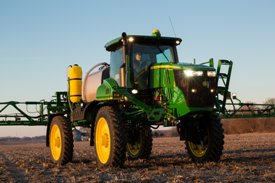
The R4030 Self-Propelled Sprayer has a 3028-L (800-gal), 304 grade stainless-steel solution tank that has been designed for growers and custom applicators who seek a highly productive sprayer. This reliable machine can deliver additional yield potential in many cropping conditions.
The R4030 Self-Propelled Sprayer provides the total solution by delivering value through machine performance such as a smooth ride, boom size options of 18.3/27.4, 18.3/30.5, 22/36.5, or 22/40 m (60/90, 60/100, 72/120, or 72/132 ft), dry spinner spreader, and direct injection compatibility in addition to integrated technologies like the optional BoomTrac™ Pro and JDLink™ system.
Uptime and cost of operation have also been improved through decreased daily service points, corrosion-resistant fittings, and additional boom protection with a full boom breakaway and tri-directional breakaways.
The increased capabilities of this machine take this self-propelled sprayer to the next level in meeting ever-changing needs while offering exceptional value.
Operator controls within easy reach in CommandView™ III cab with integrated GreenStar™ 4600 CommandCenter™ display
 4 Series Sprayer operator station
4 Series Sprayer operator station
When operators first enter the Command View III cab, they will notice that significant changes have been made. Key sprayer controls are more easily accessible to the operator on the redesigned CommandARM™ control panel and the multifunction handle has a more ergonomic fit and feel.
The multifunction handle has six reconfigurable buttons, a scroll to select speed range, and allows operators to better manage their headlands with the Headland Management System (HMS™) button. To finish out the upgrades, the GreenStar™ display has been upgraded to a faster, more user-friendly 4600 CommandCenter™ display, which allows operators to efficiently capture, manage, and transfer data.
Comfort continues to be enhanced by the ComfortCommand™ seat, which offers both fore-aft and lateral attenuation along with 15 degrees of right-hand seat swivel on all cab options. For first-class comfort, the premium cab offers a heated/ventilated leather seat and light-emitting diode (LED) cab lights.
The 4 Series Sprayers are JDLink™ telematics system capable, which enable features such as John Deere Wireless Data Transfer (WDT), Service ADVISOR™ Remote diagnostics, and Remote Display Access (RDA). These integrated solutions enable additional uptime and reduce cost of operation. All of the CommandView III cab features allow operators to run longer hours, increasing the ability to get more acres sprayed in a day.
Steel and carbon-fiber booms feature swing-link suspension for optimum stability
Make fewer passes through the field and reduce compaction, as well as time spent spraying, with John Deere booms.
All John Deere booms are more stable due to the swing link suspension, which helps translate rough areas in the field into horizontal (side-to-side) movement of the boom rather than lateral (up and down) movement. This additional stability means increased productivity as the boom now has the ability to more accurately maintain spray height above the crop, delivering a precise spray pattern. The swing link suspension also translates into uptime as the additional stability means less crop damage, resulting in less mechanical boom damage.
The enhanced design allows the boom to unfold and fold faster, getting the operators into the field quicker, and the flat fold design delivers superior transport visibility.
Automate tasks from filling station with Solution Command System
 Solution Command offer push button loading
Solution Command offer push button loading
 12-button keypad and micro-display
12-button keypad and micro-display
4 Series Sprayers are available with the SCS and have been completely redesigned to allow quick and easy operation at the load station for all operator skill levels. The optional system allows complete automation at the load station with a 12-button keypad. The features include the following:
- Fill station light on/off
- Pump on/off
- Agitation
- Pump speed increase
- Pump speed decrease
- Eductor on/off
- Master on/off
- Automated rinse cycle
- Visual nozzle check
- Pull-on fill
- Push-on fill
- Target fill
The system also features a micro-display, providing real-time feedback on the system operations, as well as ability to select a rinse method and the ability to monitor progress during the automated rinse function. Overall, the enhanced Solution Command System increases operational performance by increasing ease of use through automation at the load station.
Direct injection system expands carrying capacity for raw chemicals
 Field-installed 511-L (135-gal.) direct-injection system
Field-installed 511-L (135-gal.) direct-injection system
 Field-installed 889-L (235-gal.) direct-injection system
Field-installed 889-L (235-gal.) direct-injection system
As solution tank mixes become more complex, operators need a better way to manage the products they are mixing in helping to reduce the risk of chemical residue. The integrated direct-injection system provides an additional carrying capacity for raw chemicals and allows injection of single, dual, or triple products directly into the boom depending on installed configuration.
| Machine | Direct injection carrying capacity |
Injection capability |
| R4030/R4038 model year 2015 and older (serial number 10,999 and lower) |
511 L (135 gal.) | Inject up to two chemicals (one high volume, one low volume) |
| R4030/R4038 model year 2016 and newer (serial number 11,000 and higher) |
889 L (235 gal.) | Inject up to three chemicals (two high volume, one low volume) |
| R4045 | 889 L (235 gal.) | Inject up to three chemicals (two high volume, one low volume) |
NOTE: Low-volume tanks and pumps must be configured with at least one high-volume tank and pump. High-volume tank and pump can be configured by itself.
Direct injection helps provide quicker changeovers and faster cleanouts while also helping to minimize the risk of using multiple chemicals. This is accomplished by allowing operators the ability to isolate higher-residual-risk chemicals in the injection system while mixing lower-risk chemicals in the solution tank.
The minimum and maximum application rates for each pump are as follows:
| Direct injection pump system | High-rate pump | Low-rate pump |
| Application rate range (minimum to maximum) |
148-5900 mL/min (5-200 oz/min) | 29.6-1183 mL/min (1-40 oz/min) |
| Agitation capability | Not available – suspension products not recommended | Not available – suspension products not recommended |
NOTE: See Operator’s Manual for additional details based on boom size and speed range, and refer to Tools/Direct Inject Calculator within the ApplyPlus™ mobile app (download via Apple® App Store® or Google Play™ store).
Apple and App Store are trademarks of Apple Inc. Google Play is a trademark of Google LLC.
ExactApply™ nozzle control delivers precise application with up to 20 acres per hour of added productivity
 Turn compensation mode
Turn compensation mode
 Individual nozzle control mode
Individual nozzle control mode
John Deere’s intelligent nozzle control system ExactApply helps producers better manage drift and deliver a precise application. By maintaining target rate and pressure over a wider speed range, ExactApply can improve productivity up to 20 acres per hour*.
*NOTE: Assumes a 3.2-km/h (2-mph) average operating speed increase.
ExactApply is offered as a factory-installed option as well as a performance upgrade kit that can be added to existing 4 Series Sprayer models.
How it works
The ExactApply system features multiple modes of operation including pulse-width modulation (PWM) and individual nozzle control:
- 15-Hz PWM pulses one solenoid to achieve a consistent droplet size and maintain spray pressure throughout a wider range of speeds and application rates.
- 30-Hz PWM (combined mode) pulses both solenoids in the ExactApply nozzle body at 15 Hz, providing superior coverage. Combined mode allows ExactApply to have a 25 percent increased flow over current competitive systems in the market.
- AutoSelect A/B automatically switches between two nozzles to maintain the desired spray pressure range while spraying conventionally.
- Turn compensation varies the rate across the boom, ensuring the desired application rate. The rate decreases on the inside of the turn to not subject crop to chemical burn, while the rate on the outside of boom increases, ensuring the crop receives the desired application rate.
- Individual nozzle control minimizes overlap by controlling product application through individual nozzles. This reduces chemical cost and ensures the product is placed where it is needed most. In comparison, traditional nozzle control functions in 11 sections, meaning section widths vary from 2.4 to 3.35 m (8 to 11 ft), depending upon boom width.
Precision Ag Technology enables you to monitor performance and maximize productivity
 Connect Mobile actual rate map and pressure map in split screen gives the operator deeper understanding of machine performance
Connect Mobile actual rate map and pressure map in split screen gives the operator deeper understanding of machine performance
Connect Mobile overview
John Deere Connect Mobile is a solution that utilizes an Apple® iPad® tablet in the cab that provides the operator a better understanding of the sprayer’s performance. Connect Mobile documents and displays several sprayer performance attributes, helping the operator monitor and more easily detect problems that can occur while spraying. Connect Mobile also has a common user interface that makes it easy to use between different pieces of John Deere equipment. Once the job is done, the iPad with the spraying data can be utilized to perform basic crop scouting activities in the field.
Spraying attributes
Monitor key performance indicators in map layers and dashboard tiles such as:
- Actual rate
- Rate deviation
- Pressure
- Ground speed
- Droplet size
- Target rate
- Flow rate
- Tank volume
- Productivity
- Fuel rate
In base equipment
Connect Mobile hardware is factory installed on all model year 2017 and newer R4030, R4038, R4044, R4045, and R4060 Sprayers, making it easy to get started with Connect Mobile.
Learn more about Connect Mobile in the Field and Crop Solutions section within the Precision Ag Technology product line and how it can improve the quality of a spraying job.
iPad and Apple are trademarks of Apple Inc.
Increase versatility with a DN456 Dry Spinner Spreader
Keep your machines working for you by converting them to dry nutrient applicators with the addition of a New Leader® DN456 Dry Spinner Spreader. This conversion can be completed in as little as 4 hours and involves the removal of the wet solution skid and the installation of the dry spinner spreader.
The DN456 features a carrying capacity of up 5.6 m3 (200 cu ft) or 6.6 tons of dry fertilizer (not approved for ag lime) and is capable of variable rate applications from 34 kg/ha (75 lb/acre) up to 3 ton/acre. The 1.83-m (72-in.) spinner heights allow spread width up to 32 m (105 ft) as it propels material across the pass. The New Leader G4 spinner technology provides a consistent spread pattern across the field for uniform pass to pass application.
The DN456 can be ordered with either 304 stainless-steel or 409 painted spreader material in single or dual product bin configurations with a #4 belt over chain conveyor.
New Leader is a registered trademark of Highway Equipment Company.
Features
Take advantage of the R4023 designed for versatility
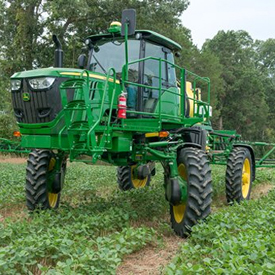

Built with the same kind of innovative thinking as its popular 4 Series siblings, the R4023 Self-Propelled Sprayer combines versatility, productivity, and affordability in a 2271-L (600-gal.) sprayer.
The option of either a wide or narrow axle configuration enables this sprayer to fit a wide range of row spacing needs. Additionally, the R4023 offers key features that provide for a smooth ride that is necessary for those long days in the field.
Equipped with up to a 27.4-m (90-ft) fold feature, the R4023 allows the operator to fold the boom in quickly for headland turns. With the ability to add precision ag productivity boosting features, the R4023 enables more accurate, efficient, and comfortable spraying applications.
24.4-m and 27.4-m (80-ft and 90-ft) booms can fold in outer wing to spray in tight spaces
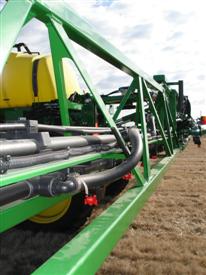 Interchangeable inner booms
Interchangeable inner booms
 3-D boom structure
3-D boom structure
The R4023 Sprayer's booms are built with high-strength square tube.
The boom incorporates a strong 3-D design. This design gives the boom more strength to resist fore-aft loading generated by starts, stops, and turns, as well as twisting loads caused by folding and unfolding operations.
The boom plumbing and nozzles are set between and up inside the two bottom square tubes of the boom structure. This protects the nozzle bodies from hitting objects that could damage the sprayer or affect the spray pattern.
The R4023 boom comes in an 18.3-m/24.4-m (60-ft/80-ft) or 18.29-m/27.44-m (60-ft/90-ft) configuration. Simply fold in the outer wing and go from spraying at 24.4 m/27.44 m to 18.3 m (80 ft/90 ft to 60 ft). When the outer wing is folded over top, it is supported by cradles to ensure it will remain in place and secure while spraying in the 18.3-m (60-ft) configuration in rough fields.
Increased boom sections provide the operator more precise application:
- 24.4-m (80-ft) boom-5 sections
- 27-m (90-ft) boom-7 sections
The breakaway ends of the boom offer the operator protection against damaging the boom if the boom unexpectedly hits an obstacle. The breakaway section of the boom uses a design that holds the breakaway from breaking backward while operating normally in the field, but when something is contacted, it will move rearward and out of the way to prevent major damage.
Each breakaway section resets using a spring, and then resets back to the spray position.
When the booms are folded in, the transport cradles on the machine support a large portion of the boom that, in turn, spreads out the stress.
While in transport position, the booms are cradled so that visibility is maximized to either side of the sprayer. By folding the booms flat, visibility is increased and the overall height of the machine is not affected.
Turbocharged PowerTech™ PSS 4.5L Tier 4 diesel engine delivers 129 kW (173 hp)
 4.5L John Deere PowerTech PSS diesel engine
4.5L John Deere PowerTech PSS diesel engine

The R4023 Sprayer provides 129 kW (173 hp) with a 5 percent power bulge to 136 kW (182 hp) and 6071 kg/cu m (538 lb-ft) of peak torque to get through tough field conditions.
John Deere PowerTech PSS (two-valve) 4.5L engine features include:
- Four-cylinder, eight-valve head (two valves per cylinder)
- Cooled exhaust gas recirculation (EGR)
- Exhaust filters
- Selective catalytic reduction (SCR)
- Air-to-air charge air cooler (CAC), aftercooled
- High-pressure common rail (HPCR) fuel injection system
- Series turbocharger
In addition to reducing emissions and lowering engine idle noise, its compact size allows it to fit neatly under the hood for great visibility of the rows passing underneath the operator.
An increase in fuel tank size makes it possible to spray for up to 16 hours without refueling. By equipping the R4023 Sprayer with a 310-L (82-gal.) fuel tank, the operator will have plenty of fuel to spray for a full day.
Handle rough and uneven terrain with ease through soft shock technology
The R4023 now offers two factory installed shock solutions to accommodate various field conditions. For optimal comfort in rough or uneven terrain conditions such as no-till or stripped fields, a Soft Shock option is now available.
The Soft Shock will take the place of the adjustable shock dampener used on the 4630 and will be offered as a factory-installed option. This fixed shock provides 50 percent less dampening force which allows for a smooth ride up to 32.2 km/h (20-mph) spray speed in those uneven field conditions. The Soft Shock may also provide a more responsive feel for operators in turns or when starting/stopping quickly.
NOTE: The standard shock option is unchanged from previous models and is recommended for general use.
Air bag/shock suspended axle provides a comfortable ride even in rough conditions
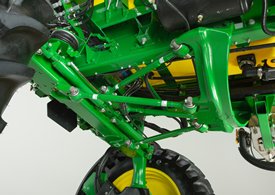 Cast mount for connecting rods
Cast mount for connecting rods

The suspension design on the R4023 Sprayer uses a four-bar link system along with an air bag and shock combination to provide a comfortable ride.
Two large air springs sit atop each axle, similar to those used on over-the-road trucks and other John Deere sprayers. These air springs are dampened with oil-filled shocks to smooth the ride.
Connecting rods link the axle to the large cast mount that is bolted to the C-channel frame with a Huck® bolt. The axle-connecting rods are parallel for vertical motion and cross linked for lateral stability.
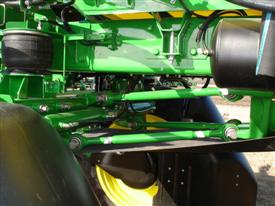 Air bag/shock suspension
Air bag/shock suspension

The R4023 Sprayer's standard suspension provides for 152 mm (6 in.) of travel at the air bag. The air springs are underneath the frame; therefore, visibility of the rows passing underneath is free of suspension components.
The air springs are adjusted by adding or removing air through a standard air-stem valve on top of each spring or, if the sprayer is equipped with auto air-spring leveling, the air springs will inflate to the optimum level for the best-possible ride.
Auto air-spring leveling system adjusts for optimal field performance
The auto air-spring leveling system is standard equipment. This feature maintains ride height, ensuring 102 mm (4 in.) of travel up and down at all times for 203 mm (8 in.) of total travel. The operator does not have to individually fill each bag or deflate each bag for transport, saving as much as 10 minutes. A switch located near the solution loading system deflates all four bags at one time. Once the machine is running, the on-board air compressor automatically inflates the bags to the optimal set ride height.Huck is a trademark of Alcoa Incorporated.
Fit variety of cropping row widths with wide and narrow axle options
 Wide axle, 234 cm to 307 cm (92 in. to 121 in.)
Wide axle, 234 cm to 307 cm (92 in. to 121 in.)
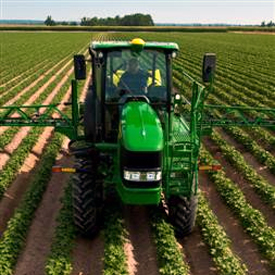 Narrow axle, 183 cm to 224 cm (72 in. to 88 in.)
Narrow axle, 183 cm to 224 cm (72 in. to 88 in.)
Two axle widths are available to best fit a variety of cropping row widths.
The narrow width axle has a tread width from 183 cm to 224 cm (72 in. to 88 in.) and a clearance of 112 cm (44 in.). The wide axle has a tread width from 234 cm to 307 cm (92 in. to 121 in.) and a clearance of 127 cm (50 in.). Axle range for wide machines varies slightly depending on the option (hydraulic vs. manual tread adjust) that is being used.
NOTE: In order to achieve 229-cm (90-in.) tread spacing, IF320/80R42 tires must be used with AN401678 rims. Please see your local John Deere Dealer for more information.
With these tread spacings, the R4023 Sprayer holds an impressive 46-54 weight split when unfolded, fully loaded. This weight split helps to reduce compaction through the field and keeps the power to the ground.
The wide axle is ideal for the Midwest grain farmer. With the wide axle option, the operator can straddle three rows at 76.2-cm (30-in.), 81.3-cm (32-in.), 86.4-cm (34-in.), 91.4-cm (36-in.), 96.5-cm (38-in.), or 101.6-cm (40-in.) spacing or four rows at 76.2-cm (30-in.) spacing.
The narrow axle is ideal for the cotton or specialty crop farmer. With the narrow axle option, the operator can straddle two rows at 91.4-cm (36-in.), 96.5-cm (38-in.), or 101.6-cm (40-in.) row spacing.
Optimal weight distribution maximizes window to operate in field
Having the optimal weight distribution results in a lighter footprint leaving less compaction and less damage to the field, allowing the operator to get into the field earlier.
The R4023 Sprayer was built with the optimal weight distribution.
R4023 Self-Propelled Sprayer |
Front weight |
Rear |
Machine weight |
Weight |
|
|
Total |
Total |
Total |
Front |
Rear |
| Base machine empty with booms folded, 24.3-m (80-ft) boom | 5,048 (11,105) |
3,227 (7,100) |
8,275(18,205) |
61 |
39 |
| Base machine empty with booms unfolded, 24.3-m (80-ft) boom | 4,220 (9,285) |
4,055 (8,920) |
8,275 (18,205) |
51 |
49 |
| Base machine full water with booms folded, 24.3-m (80-ft) boom | 5,912 (13,006) |
5,036 (11,079) |
10,948 (24,086) |
54 |
46 |
| Base machine full water with booms unfolded, 24.3-m (80-ft) boom | 5,146 (11,320) |
5,802 (12,765) |
10,948 (24,086) |
47 |
53 |
CommandARM™ console and multifunction handle position controls within easy reach for improved operator experience
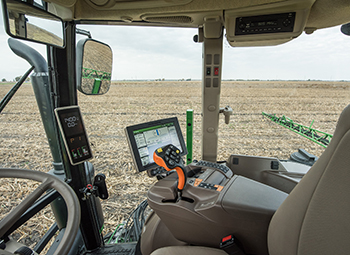 R4023 operator station
R4023 operator station
When operators first enter the model year 2018 R4023 cab, they will notice that there have been significant changes made. Key sprayer controls are more easily accessible to the operator on the redesigned CommandARM and the multifunction handle has a more ergonomic fit and feel.
The multifunction handle has six reconfigurable buttons, a scroll to select speed range, and allows operators to better manage their headlands with the Headland Management System (HMS™) button.
To finish out the upgrades, the GreenStar™ display has been upgraded to a faster, more user-friendly 4600 CommandCenter™ display, which allows operators to efficiently capture, manage, and transfer data.
Precision Ag Technology enables you to monitor performance and maximize productivity
 Connect Mobile actual rate map and pressure map in split screen gives the operator deeper understanding of machine performance
Connect Mobile actual rate map and pressure map in split screen gives the operator deeper understanding of machine performance
Connect Mobile overview
John Deere Connect Mobile is a solution that utilizes an Apple® iPad® tablet in the cab that provides the operator a better understanding of the sprayer’s performance. Connect Mobile documents and displays several sprayer performance attributes, helping the operator monitor and more easily detect problems that can occur while spraying. Connect Mobile also has a common user interface that makes it easy to use between different pieces of John Deere equipment. Once the job is done, the iPad with the spraying data can be utilized to perform basic crop scouting activities in the field.
Spraying attributes
Monitor key performance indicators in map layers and dashboard tiles such as:
- Actual rate
- Rate deviation
- Pressure
- Ground speed
- Droplet size
- Target rate
- Flow rate
- Tank volume
- Productivity
- Fuel rate
In base equipment
Connect Mobile hardware is factory installed on all model year 2017 and newer R4030, R4038, R4044, R4045, and R4060 Sprayers, making it easy to get started with Connect Mobile.
Learn more about Connect Mobile in the Field and Crop Solutions section within the Precision Ag Technology product line and how it can improve the quality of a spraying job.
iPad and Apple are trademarks of Apple Inc.
ExactApply™ nozzle control delivers precise application with up to 20 acres per hour of added productivity
 Turn compensation mode
Turn compensation mode
 Individual nozzle control mode
Individual nozzle control mode
John Deere’s intelligent nozzle control system ExactApply helps producers better manage drift and deliver a precise application. By maintaining target rate and pressure over a wider speed range, ExactApply can improve productivity up to 20 acres per hour*.
*NOTE: Assumes a 3.2-km/h (2-mph) average operating speed increase.
ExactApply is offered as a factory-installed option as well as a performance upgrade kit that can be added to existing 4 Series Sprayer models.
How it works
The ExactApply system features multiple modes of operation including pulse-width modulation (PWM) and individual nozzle control:
- 15-Hz PWM pulses one solenoid to achieve a consistent droplet size and maintain spray pressure throughout a wider range of speeds and application rates.
- 30-Hz PWM (combined mode) pulses both solenoids in the ExactApply nozzle body at 15 Hz, providing superior coverage. Combined mode allows ExactApply to have a 25 percent increased flow over current competitive systems in the market.
- AutoSelect A/B automatically switches between two nozzles to maintain the desired spray pressure range while spraying conventionally.
- Turn compensation varies the rate across the boom, ensuring the desired application rate. The rate decreases on the inside of the turn to not subject crop to chemical burn, while the rate on the outside of boom increases, ensuring the crop receives the desired application rate.
- Individual nozzle control minimizes overlap by controlling product application through individual nozzles. This reduces chemical cost and ensures the product is placed where it is needed most. In comparison, traditional nozzle control functions in 11 sections, meaning section widths vary from 2.4 to 3.35 m (8 to 11 ft), depending upon boom width.
Gain the advantages of a JDLink™ connected machine
 Monitor machines on the go
Monitor machines on the go
 Connectivity provides data that drives better decisions
Connectivity provides data that drives better decisions
Customer needs and their success is John Deere’s focus. As functionality becomes more accepted and even expected, that functionality moves from being optional to being included with the machine. In model year 2019, AutoTrac™ guidance and documentation was included on machines equipped with a 4600 CommandCenter™ Display. Five years of JDLink is also included with the purchase of all model year 2020 machines equipped with a 4G LTE Modular Telematics Gateway (MTG). The functionality of JDLink on these machines includes everything that was previously included with JDLink Access + Remote Display Access (RDA) and JDLink Connect subscriptions. This added connectivity enables customers to more easily realize the value of a connected machine.
- Easily transfer data and collaborate with trusted advisors to plan your field work quickly. You or your employees can spend more time in the field working rather than sitting on a headland setting up the technology. With a connection between John Deere Operations Center and your machines, changes to field plans occur as needed. Those changes may include changes in varieties, application rates, or machines.
- Better enable data-driven decisions. By using the insights gathered from machines along with the tools in Operations Center (e.g., Field Analyzer, Field Analyzer Beta, and Machine Analyzer) you can understand how your fields are performing and what field plans had an impact. John Deere Operations Center gives you access to more than 100 connected software tools, so you have the ultimate choice of popular industry tools. And, if you don't want to analyze the data yourself, you can share the data with those that help you make decisions to provide the insights you need.
- Report work completed accurately and timely for compliance and billing purposes.
- Increase machine uptime with Connected Support. Your local John Deere dealer can provide remote monitoring services and diagnostics to help keep your machines up and running, reduce your maintenance expenses through early detection of problems, and provide over-the-air software updates for displays, receivers, and controllers.
- Get quick in-field support with RDA. You can monitor your machines from your office computer or a mobile device on the go.
- Remotely manage machines and employees to give you insights into how they are performing. If machines are being underutilized or field operations are not being properly conducted, you can put plans in place to improve productivity.
- Quickly make changes to improve your harvesting operations by remotely viewing and adjusting combine settings.
To use JDLink, the following is required:
- MTG
- An active JDLink subscription
- A John Deere Operations Center account to access machine and agronomic data
Features
Understanding strip till
Producing more work out of every liter or gallon of fuel is imperative for boosting the profitability of farm operations. Strip till is one practice seeing significant growth due to the following:
-
Efficient nutrient placement
-
Seedbed preparation (warmer, dryer soils)
-
Increased water infiltration
-
Decreased soil erosion
-
Reduced compaction
-
Moisture conservation in arid climates
-
Ability to maintain or increase yields
What is strip till?
Strip till combines the soil drying and warming benefits of conventional tillage with the soil-protecting advantages of no-till by disturbing only the portion of the soil that is to contain the seed row.
This is done by tilling a strip of soil 203 mm to 254 mm (8-in. to 10-in.) wide in the fall or spring to prepare a seedbed, leaving the rest of the soil surface undisturbed.
Corn grown in a strip-till system consistently yields as well as corn grown in a conventional-till system and can yield better than no-till corn crops planted on the same date, according to research by agronomist Tony Vyn of Purdue University.
Not only is strip till a conservational type of tillage, but it also allows farmers to apply recommended rates of fertilizer in a zone from 152 mm to 203 mm (6 in. to 8 in.) deep in the same pass. A narrow knife forms a small tunnel underneath the soil, trapping the fertilizer (dry, liquid, or gas) in a zone for the next crop to utilize.
This tillage strip and placement of fertilizer is followed by the planter, in the same direction, for best crop utilization. In many situations, producers moving from conventional tillage to strip till have found a reduction in trips across the field by as many as four trips.
Strip-till challenges
For some producers, strip tilling is a fall practice with a small application window before the ground freezes. For others, the choice is spring strip till with an equally small window before the start of planting.
As with any farming practice, strip till has challenges that producers need to address:
-
Potential short application window
-
Consistently following the strip with the planter
-
Consistently managing large amounts of residue
-
Proper nutrient placement
-
Properly preparing a consistent seedbed
Excellent residue handling
Consistency is extremely important in all aspects of the farming operation: emergence, seed spacing, chemical application, corn head/platform operation, and chaff distribution.
That goal is not to be lost in strip-till residue management.
The biggest challenge is in high-yielding corn-on-corn acres. And with these acres on the rise, it is very important producers understand what goes into successfully managing residue.
In theory, the crop would be standing perfectly at harvest, and the combine would aggressively and evenly distribute residue across each and every field, which would virtually eliminate the need for adjustments to be made to the strip-till unit.
In reality, this is not always the case as down crops, worn combine parts, and varying moisture levels in the residue all play a role from field to field.
This creates a challenge to consistently manage residue in a strip-till application, because inconsistencies in the residue lead to inconsistent seedbeds, planter performance, plant stands, and eventually yields.
What does it take to manage residue?
Creating a strip that is free of residue is the first step in seedbed preparation. Producers know the challenge of slicing a thick mat of soybean residue one day, moist cornstalks the next day, and then moving into dry residue the following day. Producers must have:
-
Properly adjusted and operated combine
-
Large front-cutting coulter has more cutting edge than a smaller one to grab, trap, and cut residue. Dry residue has to be managed differently than wet residue—coulters usually need to be set shallower to grab and cut the fluffy stalks. Wetter stalks may require the coulters to be set deeper to chase that stalk down into the soil and prevent hairpinning. If stalks are not cut properly, residue that is not sized can cause plugging in the components on the rear of the machine and create difficulties for the row cleaners.
-
Deep frame to allow enough clearance for the residue to settle down before it gets to the row cleaners. Field cultivators today have much deeper frames than 10 and 20 years ago for one simple reason: better residue flow.
-
Large, aggressive, adjustable row cleaners. Residue that is not moved out of the row can get wrapped around the nutrient shank and mixed into the seedbed, causing inconsistencies in seed placement and emergence. Row cleaners that are set too deep and constantly gouging the ground throw too much soil in between the strips.
Consistent residue management is achieved through proper adjustments of heavy-duty components.
See the ground-engaging and frame sections of the sales manual for more details on the key components to managing residue.
Seedbed preparation
Experienced operators know there is one shot at preparing the seedbed in a strip-till application. Once the residue has been properly managed, the following components must be working together:
-
The spring-cushioned nutrient shank needs to be operating at the proper depth to lift an adequate amount of soil to be brought back in to form the strip. The shank must also have enough spring pressure to maintain its depth to keep a consistent amount of soil being disturbed.
-
As the nutrient shank lifts the soil, large adjustable closing disks are needed to bring the soil back into the strip and prepare the seedbed. Soil types and moisture content can greatly affect the amount and consistency of the soil that is brought back in. The closing disks need to have adjustments for side to side, pitch, and vertical position as hard soils flow differently than soft soils. Improperly set closing disks may not grab enough soil to build the berm and the end result before planting could be a valley where a mound should be.
-
For some producers, the last step in seedbed preparation is using a rolling basket to size and shape clods and firm the berm. In high-residue conditions, the row cleaners move a lot of residue between the rows that can hang up and plug on the baskets. It is important the baskets are able to flow residue and condition the strip.
Machine adjustments
The ability to adjust a machine as conditions change is key to productivity and top performance. The 2510S Residue Master™ utilizes many components producers are accustomed to as well as many innovative adjustment:
- Fore to aft
- Turnbuckle on the T-hitch uses an on-board wrench for leveling front to rear. A few turns in either direction raises or lowers the front of the machine.
- Single-point depth control
- Overall operating depth is set at one location on the front of the machine by turning an adjustment rod.
- Side to side
- Leveling the machine from side to side is done on top of the frame at each wing wheel module with an adjustment wrench and cylinder eye bolt.
- Front coulter gang
- Operating depth of the 635-mm (25-in.) coulter gang is set by adjusting the inside hydraulic valve located on the front of the machine and making use of continuous hydraulic pressure. By increasing pressure, the operating depth is increased as well.
- Row cleaners
- The 406-mm (16-in.) row cleaners can be adjusted from disengaged (fully raised) to engaged (fully lowered) or anywhere in between utilizing a 30-mm socket and screw adjustment. An indicator ensures consistent adjustment from row to row.
- Closing disks
- There are three different adjustments for the closing disks:
- Vertical position of the closing disks
- Pitch of the blade
- Side-to-side position
- Operating depth of the closing disks are set by using cylinder stops in combination with adjusting the outside hydraulic valve located on the front of the machine and making use of continuous hydraulic pressure. By increasing pressure, the operating depth is increased as well.
- There are three different adjustments for the closing disks:
The pitch of the blades and side-to-side position is adjusted by moving hardware to various bolt positions.
2510S Residue Master™ pictures
 Coulter gang sizing residue
Coulter gang sizing residue
 Strips behind 16-row Residue Master
Strips behind 16-row Residue Master
 16-row Residue Master with tow-behind cart
16-row Residue Master with tow-behind cart
 12-row Residue Master in soybean stubble
12-row Residue Master in soybean stubble
 12-row Residue Master in corn stubble
12-row Residue Master in corn stubble
 Strips in corn stubble
Strips in corn stubble
 Tow-between 1910 Cart and Residue Master
Tow-between 1910 Cart and Residue Master
 Strips in corn residue on rolling terrain
Strips in corn residue on rolling terrain
Transport dimensions, spacing, and horsepower requirements
762-mm (30-in.) spacing
Size |
Transport width |
Transport height |
Horsepower (hp) requirements |
Notes |
12 row |
5.33 m |
3.91 m |
25 hp to 30 hp per shank at 152-mm to 203-mm |
425 engine hp minimum recommended if utilizing |
16 row |
5.77 m |
4.17 m |
25 hp to 30 hp per shank at 152-mm to 203-mm |
475 engine hp minimum recommended if utilizing |
Transport of 16 row
 16-row Residue Master™ folding
16-row Residue Master™ folding
 16-row Residue Master folding
16-row Residue Master folding
 16-row Residue Master folding
16-row Residue Master folding
 16-row Residue Master folding
16-row Residue Master folding
 16-row Residue Master folding
16-row Residue Master folding
 16-row Residue Master tightly folded
16-row Residue Master tightly folded
Frame depth
The next level of frame technology has been introduced into the frame of the 2510S. Cast-steel saddle joints connect the 102-mm x 152-mm (4-in. x 6-in.) frame tubes and provide the backbone and support needed for the required speeds and loads of the strip-till unit.
A fore-aft frame depth of 2.36 m (93 in.) is unmatched in the strip-till market and provides the clearance necessary to flow residue in high-yielding corn-on-corn applications.
An adequate distance between the front coulters allows the residue to settle down before it gets to the row cleaner.
 2.36 m (93 in.) of frame depth
2.36 m (93 in.) of frame depth
Maintenance-free bearings
High-density polymer bearing sleeves
 High-density polymer mainframe rockshaft bearing
High-density polymer mainframe rockshaft bearing

Owners and operators alike have expressed the need to reduce the time required for daily maintenance. Applicators also do not like to crawl under the machine to grease the rockshaft bearings.
The 2510S Strip Till employs a high-density polymer bearing sleeve in each of the heavy-duty rockshaft arms for the mainframe, wing frames, and rear hitch.
The poly sleeves reduce the friction, wear, and force needed for operation. The result is a maintenance-free bearing (no greasing) with increased reliability.
Three-year warranty offered
The three-year warranty on any 2510 covers:
- All frame members including depth control wheel modules (weldments and tubes), wing-fold components, the front hitch, gang bolts, and spools
All other components (disk standards, hydraulics, electronics, safety lights) and attachments, such as rear hitches, are under warranty for one year as the warranty definition has not changed. The same exclusions and administration as defined in the Warranty Administration Manual applies.
The following items are not under warranty:
- Wear items such as blades, pins, hinges, hitch link, hub, and plug-in spindles
- Breakage due to rocks
- Abuse or lack of maintenance
- Use of unapproved attachments, such as tanks and rear hitches by other manufacturers
- Failure to follow operator's manual recommendations
Dura-Flex™ bearings will continue to have a two-year warranty.
Equipped for safe operation and transport
The 2510S is equipped for safe operation and safe transport with the following base equipment:
- Slow-moving vehicle (SMV) emblem
- Hydraulic transport-lockup valve
- Hitch-safety chain
- Implement warning lights
- Reflective decals
Features
Understanding strip till
Producing more work out of every liter or gallon of fuel is imperative for boosting the profitability of farm operations. Strip till is one practice seeing significant growth due to the following:
-
Efficient nutrient placement
-
Seedbed preparation (warmer, dryer soils)
-
Increased water infiltration
-
Decreased soil erosion
-
Reduced compaction
-
Moisture conservation in arid climates
-
Ability to maintain or increase yields
What is strip till?
Strip till combines the soil drying and warming benefits of conventional tillage with the soil-protecting advantages of no-till by disturbing only the portion of the soil that is to contain the seed row.
This is done by tilling a strip of soil 203 mm to 254 mm (8-in. to 10-in.) wide in the fall or spring to prepare a seedbed, leaving the rest of the soil surface undisturbed.
Corn grown in a strip-till system consistently yields as well as corn grown in a conventional-till system and can yield better than no-till corn crops planted on the same date, according to research by agronomist Tony Vyn of Purdue University.
Not only is strip till a conservational type of tillage, but it also allows farmers to apply recommended rates of fertilizer in a zone from 152 mm to 203 mm (6 in. to 8 in.) deep in the same pass. A narrow knife forms a small tunnel underneath the soil, trapping the fertilizer (dry, liquid, or gas) in a zone for the next crop to utilize.
This tillage strip and placement of fertilizer is followed by the planter, in the same direction, for best crop utilization. In many situations, producers moving from conventional tillage to strip till have found a reduction in trips across the field by as many as four trips.
Strip-till challenges
For some producers, strip tilling is a fall practice with a small application window before the ground freezes. For others, the choice is spring strip till with an equally small window before the start of planting.
As with any farming practice, strip till has challenges that producers need to address:
-
Potential short application window
-
Consistently following the strip with the planter
-
Consistently managing large amounts of residue
-
Proper nutrient placement
-
Properly preparing a consistent seedbed
Excellent residue handling
Consistency is extremely important in all aspects of the farming operation: emergence, seed spacing, chemical application, corn head/platform operation, and chaff distribution.
That goal is not to be lost in strip-till residue management.
The biggest challenge is in high-yielding corn-on-corn acres. And with these acres on the rise, it is very important producers understand what goes into successfully managing residue.
In theory, the crop would be standing perfectly at harvest, and the combine would aggressively and evenly distribute residue across each and every field, which would virtually eliminate the need for adjustments to be made to the strip-till unit.
In reality, this is not always the case as down crops, worn combine parts, and varying moisture levels in the residue all play a role from field to field.
This creates a challenge to consistently manage residue in a strip-till application, because inconsistencies in the residue lead to inconsistent seedbeds, planter performance, plant stands, and eventually yields.
What does it take to manage residue?
Creating a strip that is free of residue is the first step in seedbed preparation. Producers know the challenge of slicing a thick mat of soybean residue one day, moist cornstalks the next day, and then moving into dry residue the following day. Producers must have:
-
Properly adjusted and operated combine
-
Large front-cutting coulter has more cutting edge than a smaller one to grab, trap, and cut residue. Dry residue has to be managed differently than wet residue—coulters usually need to be set shallower to grab and cut the fluffy stalks. Wetter stalks may require the coulters to be set deeper to chase that stalk down into the soil and prevent hairpinning. If stalks are not cut properly, residue that is not sized can cause plugging in the components on the rear of the machine and create difficulties for the row cleaners.
-
Deep frame to allow enough clearance for the residue to settle down before it gets to the row cleaners. Field cultivators today have much deeper frames than 10 and 20 years ago for one simple reason: better residue flow.
-
Large, aggressive, adjustable row cleaners. Residue that is not moved out of the row can get wrapped around the nutrient shank and mixed into the seedbed, causing inconsistencies in seed placement and emergence. Row cleaners that are set too deep and constantly gouging the ground throw too much soil in between the strips.
Consistent residue management is achieved through proper adjustments of heavy-duty components.
See the ground-engaging and frame sections of the sales manual for more details on the key components to managing residue.
Seedbed preparation
Experienced operators know there is one shot at preparing the seedbed in a strip-till application. Once the residue has been properly managed, the components below must be working together.
-
The spring-cushioned nutrient shank needs to be operating at the proper depth to lift an adequate amount of soil to be brought back in to form the strip. The shank must also have enough spring pressure to maintain its depth to keep a consistent amount of soil being disturbed.
-
As the nutrient shank lifts the soil, large adjustable closing disks are needed to bring the soil back into the strip and prepare the seedbed. Soil types and moisture content can greatly affect the amount and consistency of the soil that is brought back in. The closing disks need to have adjustments as hard soils flow differently than soft soils. Improperly set closing disks may not grab enough soil to build the berm and the end result before planting could be a valley where a mound should be.
-
For some producers, the last step in seedbed preparation is using a rolling basket to size and shape clods and firm the berm. In some conditions, row cleaners can move a lot of residue between the rows that can hang up and plug on the baskets. It is important the baskets are able to flow residue and condition the strip.
Machine adjustments
The ability to adjust a machine as conditions change is key to productivity and top performance. The 2510S Medium Residue utilizes many components that producers are accustomed to, as well as many innovative adjustments.
- Fore to aft
- A turnbuckle on the T-hitch uses an onboard wrench for leveling front to rear. A few turns in either direction raises or lowers the front of the machine.
- Single-point depth control
- Overall operating depth is set at one location on the front of the machine by turning an adjustment rod.
- Side to side
- Leveling the machine from side to side is done on top of the frame at each wing wheel module with an adjustment wrench and cylinder eye bolt.
- Front-cutting coulter
- Operating depth of the 559-mm (22-in.) coulter is set by making use of two set screws.
- Optional row cleaners
- The 406-mm (16-in.) row cleaners can be adjusted from disengaged (fully raised) to engaged (fully lowered) or anywhere in between utilizing a 30-mm socket and a screw adjustment. An indicator ensures consistent adjustment from row to row.
- Floating closing disks
- The pitch of the blades and side-to-side position is adjusted by moving hardware to various bolt positions.
Transport dimensions, spacing, and horsepower requirements
Size |
Transport Width |
Transport Height |
Horsepower Requirements |
|
30-in. spacing |
|
|||
12 row |
17 ft, 6 in. |
12 ft, 10 in. |
20 hp to 27 hp per shank at 6-in. to 8-in. depth |
*425 engine hp minimum recommended if utilizing a 1910 Cart |
16 row |
18 ft, 11 in. |
13 ft, 8 in. |
20 hp to 27 hp per shank at 6-in. to 8-in. depth |
*475 engine hp minimum recommended if utilizing a 1910 Cart |
Transport of 16 row
 16-row Residue Master™ folding
16-row Residue Master™ folding
 16-row Residue Master folding
16-row Residue Master folding
 16-row Residue Master folding
16-row Residue Master folding
 16-row Residue Master folding
16-row Residue Master folding
 16-row Residue Master folding
16-row Residue Master folding
 16-row Residue Master tightly folded
16-row Residue Master tightly folded
Frame depth
The next level of frame technology has been introduced into the frame of the 2510S. Cast-steel saddle joints connect the 102-mm x 152-mm (4-in. x 6-in.) frame tubes and provide the backbone and support needed for the required speeds and loads of the strip-till unit.
A fore-aft frame depth of 2.36 m (93 in.) is unmatched in the strip-till market and provides the clearance necessary to flow residue.
An adequate distance between the front coulters allows the residue to settle down as it moves through the machine.
 2.36 m (93 in.) of frame depth
2.36 m (93 in.) of frame depth
Maintenance-free bearings
High-density polymer bearing sleeves
 High-density polymer mainframe rockshaft bearing
High-density polymer mainframe rockshaft bearing

Owners and operators alike have expressed the need to reduce the time required for daily maintenance. Applicators also do not like to crawl under the machine to grease the rockshaft bearings.
The 2510S Strip Till employs a high-density polymer bearing sleeve in each of the heavy-duty rockshaft arms for the mainframe, wing frames, and rear hitch.
The poly sleeves reduce the friction, wear, and force needed for operation. The result is a maintenance-free bearing (no greasing) with increased reliability.
Three-year warranty offered
The three-year warranty on any 2510 covers:
- All frame members including depth control wheel modules (weldments and tubes), wing-fold components, the front hitch, gang bolts, and spools
All other components (disk standards, hydraulics, electronics, safety lights) and attachments, such as rear hitches, are under warranty for one year as the warranty definition has not changed. The same exclusions and administration as defined in the Warranty Administration Manual applies.
The following items are not under warranty:
- Wear items such as blades, pins, hinges, hitch link, hub, and plug-in spindles
- Breakage due to rocks
- Abuse or lack of maintenance
- Use of unapproved attachments, such as tanks and rear hitches by other manufacturers
- Failure to follow operator's manual recommendations
Dura-Flex™ bearings will continue to have a two-year warranty.
Equipped for safe operation and transport
The 2510S is equipped for safe operation and safe transport with the following base equipment:
- Slow-moving vehicle (SMV) emblem
- Hydraulic transport-lockup valve
- Hitch-safety chain
- Implement warning lights
- Reflective decals
2510S Medium Residue pictures
 Closing disks and baskets
Closing disks and baskets
 Medium residue folded
Medium residue folded
 Skip pass in soybean stubble
Skip pass in soybean stubble
 Side view of medium residue
Side view of medium residue
 Medium residue in soybean stubble
Medium residue in soybean stubble
 Dual paddle baskets
Dual paddle baskets
Features
Various sizes and configurations available to fit the right machine to any size operation
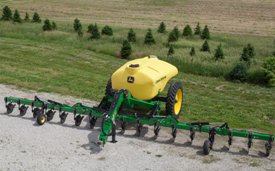
The John Deere 2510L offers several different sizes to fit any size operation, big or small.
Purpose |
Liquid application |
|
Model |
2510L Vertical-Fold – 9.14 m (30 ft) |
2510L Vertical-Fold – 12.2 m (40 ft) |
Allows application when outer wing folded |
Yes |
Yes |
Toolbar frame |
17.8-cm x 17.8-cm (7-in. X 7-in.) single bar tube | 17.8-cm x 17.8-cm (7-in. X 7-in.) single bar tube |
Operating frame clearance |
61 cm (24 in.) | 61 cm (24 in.) |
Spacing options (see below) |
76.2 cm (30 in.) |
50.8 cm (20 in.) 55.9 cm (22 in.) 76.2 cm (30 in.) 91.4 cm (36 in.) 96.5 cm (38 in.) 101.6 cm (40 in.) |
Tank sizes |
3974.7 L (1050 gal.) 5110.3 L (1350 gal.) 6813.7 L (1800 gal.) |
3974.7 L (1050 gal.) 5110.3 L (1350 gal.) 6813.7 L (1800 gal.) |
Gauge wheels |
Two |
Two |
Tank fill |
3974.7 L (1050 gal.) and 5110.3 L (1350 gal.): 5.1-cm (2-in.) bottom fill 6813.7 L (1800 gal.): 7.6-cm (3-in.) bottom fill |
3974.7 L (1050 gal.) and 5110.3 L (1350 gal.): 5.2-cm (2-in.) bottom fill 6813.7 L (1800 gal.): 7.6-cm (3-in.) bottom fill |
Coulters |
Heavy-duty 50.8-cm (20-in.) coulters |
|
Fertilizer delivery |
Knives or injectors |
|
Working depth |
Up to 10.16 cm (4 in.) |
|
Engine power requirement |
104.4-119.3 kW (140 – 160) | 119.3-141.7 kW (160 – 190 hp) |
Rate Controller |
GreenStar™ Rate Controller |
|
Number of section shutoffs |
Two or four |
Two or four |
Operating speed |
8-12.9 km/h (5–8 mph) | |
Transport width |
4.27 m (14 ft) |
4.27 m (14 ft) |
Transport height |
4.06 m (13 ft, 4 in.) |
4.06 m (13 ft, 4 in.) |
Selective control valves (SCV) required |
Three |
Four |
|
Spacing |
||||||
50.8 cm (20 in.) |
55.9 cm (22 in.) |
76.2 cm (30 in.) |
91.4 cm (36 in.) |
96.5 cm (38 in.) |
101.6 cm (40 in.) |
||
Number of coulters |
2510L Vertical-Fold |
--- |
--- |
11 or 13 |
--- |
--- |
--- |
2510L Vertical-Fold |
23 or 25 |
23 |
15 or 17 |
13 |
11 or 13 |
11 or 13 |
|
Code |
Model |
Description |
5280 |
2510L Vertical-Fold – 9.14 m (30 ft) |
11 coulters on 76.2-cm (30-in.) spacing |
5281 |
2510L Vertical-Fold – 12.2 m (40 ft) |
11 coulters on 91.4-cm (36-in.) spacing |
5299 |
2510L Vertical-Fold – 12.2 m (40 ft) |
11 coulters on 96.5-cm (38-in.) spacing |
5282 |
2510L Vertical-Fold – 12.2 m (40 ft) |
13 coulters on 91.4-cm (36-in.) spacing |
528A |
2510L Vertical-Fold – 12.2 m (40 ft) |
13 coulters on 96.5-cm (38-in.) spacing |
| 529B | 2510L Vertical-Fold – 12.2 m (40 ft) | 13 coulters on 101.6-cm (40-in.) spacing |
5283 |
2510L Vertical-Fold – 12.2 m (40 ft) |
11 coulters on 101.6-cm (40-in.) spacing |
5284 |
2510L Vertical-Fold – 9.14 m (30 ft) |
13 coulters on 76.2-cm (30-in.) spacing |
5285 |
2510L Vertical-Fold – 12.2 m (40 ft) |
15 coulters on 76.2-cm (30-in.) spacing |
5286 |
2510L Vertical-Fold – 12.2 m (40 ft) |
17 coulters on 76.2-cm (30-in.) spacing |
5287 |
2510L Vertical-Fold – 12.2 m (40 ft) |
23 coulters on 50.8-cm (20-in.) spacing |
5288 |
2510L Vertical-Fold – 12.2 m (40 ft) |
23 coulters on 55.9-cm (22-in.) spacing |
5290 |
2510L Vertical-Fold – 12.2 m (40 ft) |
25 coulters on 50.8-cm (20-in.) spacing |
John Deere GreenStar™ Rate Controller enables one-step integration
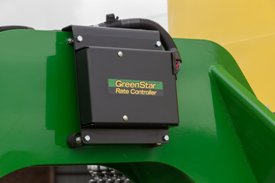 Rate controller on 2510L
Rate controller on 2510L
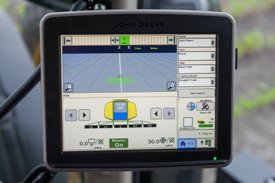 GreenStar 2630 Display
GreenStar 2630 Display
The 2510L comes standard with a GreenStar Rate Controller enabling full one-step integration of the GreenStar Display with the 2510L liquid system. This integration enables:
- Automatic rate control
- Field documentation
- Map-based prescriptions
- John Deere Section Control*
System pressure is monitored directly on the GreenStar Display and saves producers from having to monitor a manual gauge or keep it clean while in those dry, dusty fields.
John Deere Section Control reduces overlap, thus lowering input costs. The John Deere 2510L has up to five sections of control depending on size and configuration of the machine.
*John Deere Section Control activation required.
Model |
Description |
Number of Sections |
2510L Vertical-Fold – 9.14 m (30 ft) |
11 coulters on 76.2-cm (30-in.) spacing |
Two |
2510L Vertical-Fold – 12.19 m (40 ft) |
11 coulters on 91.44-cm (36-in.) spacing |
Two |
2510L Vertical-Fold – 12.19 m (40 ft) |
11 coulters on 96.52-cm (38-in.) spacing |
Two |
2510L Vertical-Fold – 12.19 m (40 ft) |
13 coulters on 91.44-cm (36-in.) spacing |
Four |
2510L Vertical-Fold – 12.19 m (40 ft) |
13 coulters on 96.52-cm (38-in.) spacing |
Four |
2510L Vertical-Fold – 12.19 m (40 ft) |
11 coulters on 101.6-cm (40-in.) spacing |
Four |
2510L Vertical-Fold – 9.14 m (30 ft) |
13 coulters on 76.2-cm (30-in.) spacing |
Two |
2510L Vertical-Fold 12.19 m (40 ft) |
13 coulters on 101.6-cm (40-in.) spacing | Four |
2510L Vertical-Fold – 12.19 m (40 ft) |
15 coulters on 76.2-cm (30-in.) spacing |
Four |
2510L Vertical-Fold – 12.19 m (40 ft) |
17 coulters on 76.2-cm (30-in.) spacing |
Four |
2510L Vertical-Fold – 12.19 m (40 ft) |
23 coulters on 50.8-cm (20-in.) spacing |
Four |
2510L Vertical-Fold – 12.19 m (40 ft) |
23 coulters on 55.88-cm (22-in.) spacing |
Four |
2510L Vertical-Fold – 12.19 m (40 ft) |
25 coulters on 50.8-cm (20-in.) spacing |
Five |
Hydraulic wing down pressure and flex-hinge design ensures accurate fertilizer placement
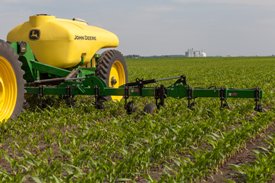 2510L Vertical-Fold in-field
2510L Vertical-Fold in-field
Accurate fertilizer application is vital to increase fertilizer efficiency and effectiveness which will help a producer reach their yield goals. In addition to mainframe down pressure, the 2510L offers hydraulic wing down pressure and a flex-hinged design that ensures accurate fertilizer placement.
Hydraulic wing down pressure
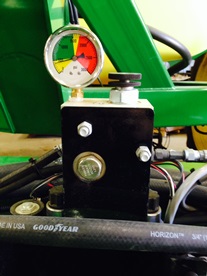 Hydraulic wing down pressure gauge
Hydraulic wing down pressure gauge

The 2510L features hydraulic wing down pressure that applies constant down pressure on the wings to maintain constant depth and application.
Flex-wing hinge design
The flex hinge allows for 5 degrees up and down on the vertical fold:
- Ensure constant contact with the ground
- Increase performance in uneven terrain
- Maintain even working depth across the entire working width
Utilize hydraulic wing kick and high-clearance toolbar frame to reduce crop damage
 2510L Vertical-Fold using wing kick
2510L Vertical-Fold using wing kick
When using side-dress application, an operator’s ability to minimize crop damage during application is paramount. The 2510L comes in base with features such as hydraulic wing kick, single reach tongue, and higher operating clearances that allow operators to reduce that damage and expand that application window.
Hydraulic wing kick
Hydraulic wing kick is a key feature that helps reduce crop damage. No more dipping into the crop and damaging corn when turning. When the operator lifts the toolbar during the turn, the wings will automatically kick up in order to increase its distance from ground to toolbar. This action allows the operator to have increased clearance on the wings, minimizing crop damage.
Single reach tongue
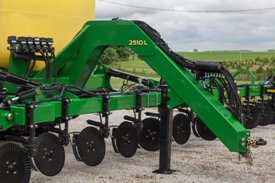 2510L tongue
2510L tongue

Unlike some fertilizer applicators with an A-frame tongue, the 2510L features a single reach tongue that is a single tube from the main cart frame to the hitch point. This allows:
- Sharper turning radius
- Reduced crop damage
- Better tractor to implement tracking
Operating toolbar frame clearance
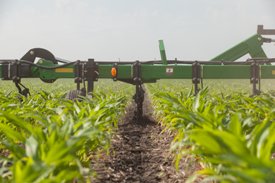 2510L frame clearance
2510L frame clearance

A 60.96 cm (24 in.) operating clearance allows the operator to maneuver in the field while minimizing crop damage.
Model |
2510L Vertical-Fold – 9.14 m (30 ft) |
2510L Vertical-Fold – 12.2 m (40 ft) |
Operating toolbar frame clearance |
61 cm (24 in.) | 61 cm (24 in.) |
Patented compact stealth tank improves machine stability
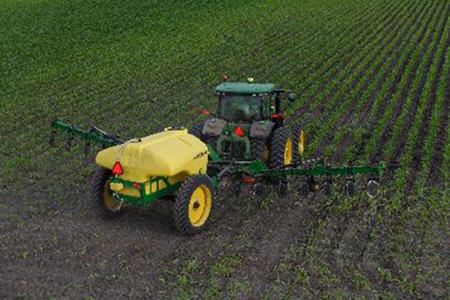 2510L Vertical-Fold tank
2510L Vertical-Fold tank
The 2510L offers an industry-exclusive tank design that gives the operator increased productivity and versatility. This patented compact stealth tank offers:
- Low center of gravity for increased stability
- Large trough-sloped sump for maximum cleanout
- Unique design that allows for operating in various row spacing from 60 in. to 144 in. depending on coulter spacing, tires, and wheels selection
Tank capacity
The large tank capacities and quick cleanout allows the operator to spend more time in the field and less time rinsing. Tank sizes that are offered for the following sizes of applicators:
Model |
2510L Vertical-Fold – 9.14 m (30 ft) and 12.2 m (40 ft) |
Tank sizes |
3974.7 L (1050 gal.) 5110.3 L (1350 gal.) 6813.7 L (1800 gal.) |
Tank fill
 5.1-cm (2-in.) tank fill
5.1-cm (2-in.) tank fill
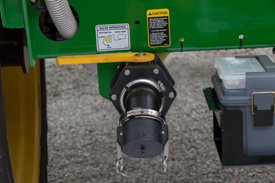 7.6-cm (3-in.) tank fill
7.6-cm (3-in.) tank fill
In order to reduce filling time, the 2510L offers 5.1-cm (2-in.) fill on 3974.7-L and 5110.3-L (1050- and 1350-gal.) tanks and 7.6-cm (3-in.) fill on 6813.7-L and 9085-L (1800- and 2400-gal.) tanks.
Tank size: |
3974.7 L |
5110.3 L |
6813.7 L |
Size of tank fill: |
5.1 cm (2 in.) |
5.1 cm (2 in.) |
7.6 cm (3 in.) |
Features
Increased nutrient stewardship
Productivity
The 2510H with dry attachment's single-disk opener design improves nutrient stewardship by properly placing nutrients to ensure plants thrive and reach their maximum yield potential while being environmentally responsible. The single-disk opener allows the operator to apply nutrients up to 16 km/h (10 mph).
Operators will benefit from proper nutrient placement and realize maximum asset utilization that can quickly apply anhydrous and dry nutrients.
This machine delivers a 50 percent increase in equipment asset utilization and application speeds up to 16 km/h (10 mph) to feed plants when they need it most and assisting producers to ensure proper which agronomics potentially reduces application rates and achieves maximum yield.
Applying nitrogen (N), phosphorous (P), and potassium (K) in the right place puts nutrients closer to the root zone where they are more readily available. Multiple university studies have shown up to a 20-bushel increase, greater in corn yields, with accurate nutrient placement applied at the right time. The single-disk opener precisely delivers dry fertilizer up to 114-mm (4.5-in.) deep and anhydrous up to the depth of 140 mm (5.5 in.).
Minimal soil disturbance
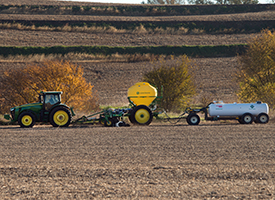 Fall application in soybean stubble
Fall application in soybean stubble
The single-disk opener on the 2510H with dry attachment utilizes a 559-mm (22-in.) blade that is angled 4 degrees to open a narrow slot for the nutrient placement.
Reduced soil disturbance and sub-surface application helps implement the nutrient reduction strategy, which is a science and technology based approach to achieving a 45 percent reduction in nitrogen and phosphorus losses to waterways.
The objectives of the nutrient reduction strategy are to reduce:
- Drinking water treatments
- Hypoxia — in Gulf and Great Lakes (most publicized)
- Runoff into Chesapeake Bay
- Point-source pollution
- Recreational use of water limitations
- Negative agriculture public perception
15-row three-season application
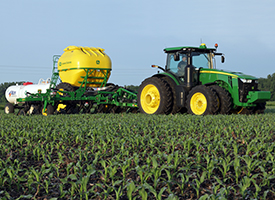 Side-dress in conventional corn ground
Side-dress in conventional corn ground
Side-dressing nitrogen (N), phosphorous (P), and potassium (K) in addition to pre-plant N, P, and K application in corn has several advantages compared to pre-plant applications only. Some of the benefits include providing these nutrients closer to when they are needed by the crop, reducing the potential for nutrient losses, and the opportunity to adjust nutrient application rates to achieve yield goals.
The underframe clearance on the 2510H with dry attachment is 914 mm (36 in.).
Images of 2510H High-Speed Applicator with dry nutrient attachment in action
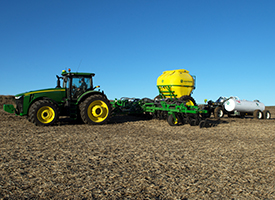 Fall applying in soybean stubble
Fall applying in soybean stubble
 Field finish in soybean stubble
Field finish in soybean stubble
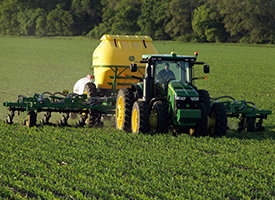 15-row side-dress application
15-row side-dress application
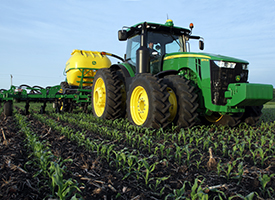 15-row side-dress in corn
15-row side-dress in corn
 In transport
In transport
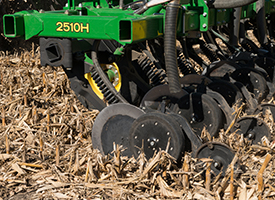 Fall application in corn stock
Fall application in corn stock
 Filling dry tank
Filling dry tank
 Minimal disturbance in corn
Minimal disturbance in corn
Transport dimensions and horsepower requirements
| Size | Transport width | Transport height | Engine horsepower requirements |
| 762-mm (30-in.) spacing: | |||
| 15-row 6 ton | 5.64 m (18.5 ft) | 3.35 m (11.4 ft) | 11.2 to 20.9 kW (15 to 28 hp) engine hp per opener |
| 15-row 9 ton | 5.64 m (18.5 ft) | 3.98 m (13.1 ft) | 11.2 to 20.9 kW (15 to 28 hp) engine hp per opener |
Equipped with multiple safety features
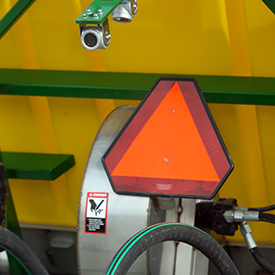 Slow-moving vehicle sign
Slow-moving vehicle sign
The 2510H with dry attachment is equipped for safe operation and safe transport with the following base equipment:
- Slow-moving-vehicle (SMV) emblem
- Hitch safety chain
- Implement warning lights
- Reflective decals
- Hydraulic valve flow shut-offs
- Safety railing on platform
2510H with dry nutrient attachment includes 15-row and 16-row configuration
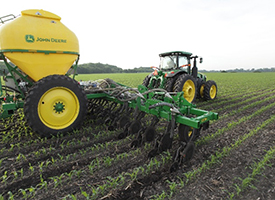 15-row 2510H with dry attachment
15-row 2510H with dry attachment
 16-row 2510H with dry attachment
16-row 2510H with dry attachment
All three of the primary nutrients – nitrogen, phosphorous, and potassium – can be applied at the right time by the 2510H with dry nutrient attachment to feed crops when they most need it. This integrated solution helps producers achieve the 4R objectives for improving application rate, coverage, and accuracy. To further improve the capabilities of this solution.
Row configuration:
The John Deere 2510H with dry nutrient attachment now has configurations for off-row and on-row dry fertilizer banding in 15-row and 16-row configurations.
With a working width of 12.2 m (40 ft), the 16-row 2510H with dry attachment can be used for pre plant and fall applications to apply on row. This allows for better matching of the tracks from application with subsequent tasks, like planting. It also makes execution of banding easier.
By applying off row, the 11.43-m (37.5-ft) wide 15-row configuration has the additional capability to side dress.
| Use season | 15-row configuration | 16-row configuration |
| Pre plant | X | X |
| Side dress | X | --- |
| Fall | X | X |
Both configurations offer 6- and 9-ton dry poly tank options that work in tandem with the applicator bar to place anhydrous and dry nutrients in the ground. As an all-in-one, fully integrated package, the 2510H with dry attachment helps provide plants with the nutrients they need, when they need them, to boost yield potential.
No retrofit options are available to convert an existing 15-row configuration to a 16-row configuration.
Features
Why a single-disk opener?
Productivity
In many areas, a conventional anhydrous application is a pass through the field at 8 km/h to 12 km/h (5 mph to 7.5 mph). To increase productivity, a few options are available:
- Increase the operating speed, which is not always possible due to horsepower limitations, and at the same time keep the knife from tripping up or soil disturbance at faster speeds
- Operate a wider applicator, which also requires more horsepower
The 2510H’s single-disk opener design has a lower draft requirement and allows anhydrous application up to 16 km/h (10 mph).
For example, an 8530 Tractor coupled with a 15-row opener 2510H can cover up to 40 acres per hour at a 16-km/h (10-mph) operating speed.
Low soil disturbance
 Fall application in soybean stubble
Fall application in soybean stubble
The single-disk opener on the 2510H utilizes a 559-mm (22-in.) blade that is angled 4 degrees to open a narrow slot for anhydrous application.
Reduced soil and residue disturbances provide a increased accuracy and placement during anhydrous application:
- In highly erodible land areas
- With no-till/min-till practices
- Looking to save money sidedressing with anhydrous application
Sidedress opportunity
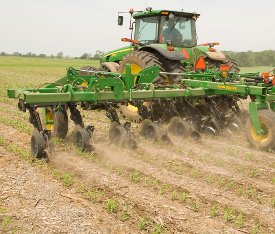 Sidedressing in soybean stubble
Sidedressing in soybean stubble

Productivity and low soil disturbance are two of the three ingredients for a successful sidedress application. The third is clearance under the frame and around the wheel modules.
Certain challenges exist when sidedressing using a conventional applicator:
- Very short window
- Soil disturbance
- Crop clearance
Early sidedress application with a conventional applicator can cause too much soil throw and damage or small corn plants. With a single-disk opener, soil disturbance is very low for early sidedressing, as early as right after planting.
As the season progresses and the corn gets taller, underframe clearance becomes vitally important to sidedressing using anhydrous application. The underframe clearance on the 2510H is 762 mm (30 in.) and there are no tandem wheel axles with low clearance. The 2510H increases the sidedress window by nearly 300 percent.
The 2510H has configurations for off-row and on-row fertilizer banding in 16-row configurations. With a working width of 12.2 m (40 ft), the 16-row 2510H can be used for pre-planting and fall applications to apply on row. This allows for better matching of the tracks from application with subsequent tasks like planting. It also makes execution of banding easier.
The 2510H High-Speed Applicator is truly a three-season machine: fall, spring, and sidedressing.
Shallow placement during anhydrous application allows for minimal soil disturbance
Traditional thinking is that anhydrous ammonia must be placed 203 mm (8 in.) deep in the soil. The 2510H High-Speed row unit places anhydrous applications at 114-mm (4.5-in.) depth, which is quite a difference from traditional thinking.
John Deere has tested this placement across the Corn Belt in real-world field applications and plot-size treatments. More than 10000 acres of spring pre-plant anhydrous ammonia application yielded no reports of seedling damage.
To further evaluate shallow placement, plot-scale studies were initiated with three university cooperators that put the concept to the test by planting right over the anhydrous application track seven days after application.
To avoid seedling damage with the 2510H, the same recommendations apply as when using a conventional shank applicator:
- Allow a window of opportunity
- Apply to the rows at an angle
- Soil moisture conditions
Retention at a shallow depth
John Deere has gone to great lengths to verify the anhydrous application retention provided by a 2510H is equal to that of a shank at a shallow depth.
Three methods were used to measure retention.
The brick soil sampling method entailed extracting a brick of soil in the injection zone 24 hours after application and then sent off to a lab for analysis. A side-by-side comparison of the 2510H with a conventional shank revealed equal retention.
The other two methods were the litmus paper test and the chamber technique to collect emissions.
All three methods revealed equal retention with a shank applicator.
Images of 2510H High-Speed Applicator in action
 Fall application in soybean stubble
Fall application in soybean stubble
 Field finish in soybean stubble
Field finish in soybean stubble
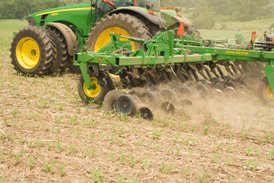 Sidedress application
Sidedress application
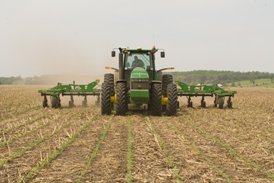 Sidedressing in corn stubble
Sidedressing in corn stubble
 Sidedress application
Sidedress application
 Drawn hitch in corn stubble
Drawn hitch in corn stubble
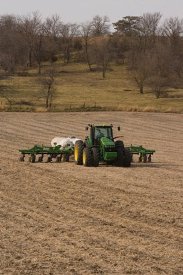 Fall application with drawn hitch
Fall application with drawn hitch
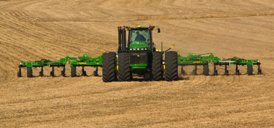 23-row fall application in soybean stubble
23-row fall application in soybean stubble
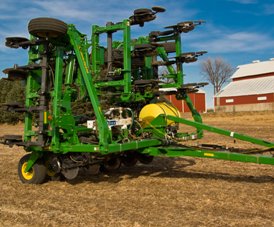 23-row folded for transport
23-row folded for transport
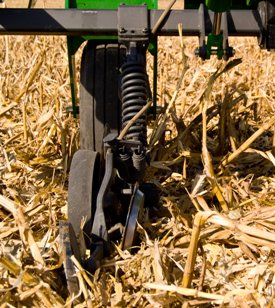 Anhydrous application in corn stubble during fall
Anhydrous application in corn stubble during fall
Transport dimensions and horsepower requirements
| Size with 762-mm (30-in.) spacing |
Transport width | Transport height | Engine horsepower requirements |
| 11 opener | 5.64 m |
3.35 m (11 ft) |
11.2 kW to 18.6 kW (15 to 25 hp) per opener |
| 15 opener | 5.64 m |
3.35 m (11 ft) |
11.2 kW to 18.6 kW (15 to 25 hp) per opener |
| 16 opener | 5.64 m |
3.66 m (12 ft) |
11.2 kW to 18.6 kW (15 to 25 hp) per opener |
| 23 opener | 5.49 m (18 ft) |
3.35 m (13 ft) |
11.2 kW to 18.6 kW (15 to 25 hp) per opener |
Three-year warranty offered on 2510H
The three-year warranty on the 2510H covers:
- All frame members including wheel modules (weldments and tubes), wing-fold components, and the front hitch
All other components (disk standards, hydraulics, electronics, and safety lights) and attachments, such as rear hitches, are under warranty for one year as the warranty definition has not changed. The same exclusions and administration as defined in the Warranty Administration Manual applies.
The following items are not under warranty:
- Wear items such as blades, pins, hinges, hitch link, and hub
- Breakage due to rocks
- Abuse or lack of maintenance
- Use of unapproved attachments such as tanks and rear hitches by other manufacturers
- Failure to follow operator's manual recommendations
Equipped with multiple safety features
The 2510H is equipped for safe operation and safe transport with the following base equipment:
- Slow-moving-vehicle emblem
- Hitch safety chain
- Implement warning lights
- Reflective decals
Improve wear, residue flow, and sealing with floating scraper
 Floating scraper
Floating scraper
The floating scraper offered on 2510H High-Speed Applicators improves wear by allowing the scraper to float and flex along the blade during application. Instead of a rigid mount, the scraper has a spring pack that floats with the blade. This increases the wear life of the scraper assembly.
The floating scraper also improves residue flow in high-residue conditions. Keeping the scraper in constant contact with the opener eliminates residue from getting caught between the scraper and the blade.
A high-wear beaver tail extension is also available on the floating scraper for the 2510H Applicator. The beavertail extension helps improve sealing in various conditions.
Ski eliminates bull dozing and increases productivity
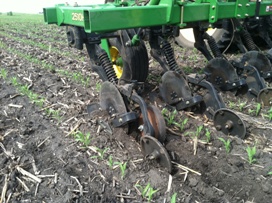 2510H High-Speed Applicator with optional ski
2510H High-Speed Applicator with optional ski
The optional ski on the 2510H High-Speed Applicator takes the place of the gauge wheel on the opener. The ski helps eliminate bull dozing of loose soil and residue in heavy primary-tillage conditions.
Features
Half the cost, half the investment - Save up to 50 cents per cu yd
Maximize productivity and minimize costs with the John Deere scraper system
Throughout the world, contractors have been moving material with conventional self-propelled scrapers or rigid/articulated trucks and excavators. John Deere scraper tractors and scrapers are a valuable solution for contractors, allowing them to move the same material using half the labor, half the investment, and saving 30 cents per cu yd to 50 cents per cu yd.
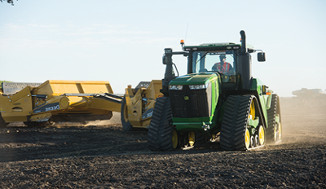 9570RX Scraper Tractor and 2412D E Ejector Scraper
9570RX Scraper Tractor and 2412D E Ejector Scraper
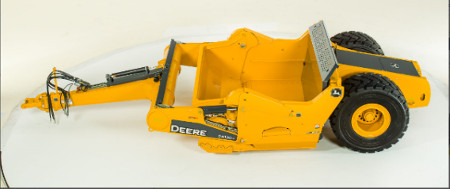 2412D E Ejector Scraper
2412D E Ejector Scraper
Half the labor
The John Deere scraper system is an independent earthmoving system requiring one operator to load, transport, and spread the materials on a job site. Self-propelled and truck/excavator earthmoving systems need additional support equipment to assist with loading and spreading the materials, increasing labor requirements.
Half the investment
Compare the purchase price of a John Deere scraper tractor and scrapers to competitive systems. Factor in the labor costs, fuel burn, daily operating expenses of all the equipment used in the system, and it all adds up to half the savings over the life of the equipment.
Saving 30 to 50 cents per cu yd
The savings are already adding up with the reduced labor requirements and lower investment costs. Experience additional savings from reduced fuel consumption by having only one tractor engine performing all of the work. Increase productivity moving more yards per cycle when using the 16-m3 or 18.3-m3 (21-cu yd or 24-cu yd) scrapers in tandem or triple configurations.
Applications for the John Deere scraper systems are as follows:
-
Residential development
-
Commercial development
-
Road construction
-
Mining/quarries
-
Levee construction
-
Reservoir construction
-
Airport construction
-
Precision leveling
AutoLoad™ system for smooth loading and efficient operation
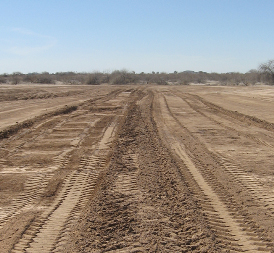 Manual loading (left) vs. AutoLoad (right)
Manual loading (left) vs. AutoLoad (right)
An innovation in the earthmoving industry exclusive to John Deere, the AutoLoad feature allows novice and experienced operators alike to be consistently productive while operating John Deere tractors and scrapers with the touch of a button, even if they have never operated tractors and scrapers.
Top-loading John Deere scrapers increase productivity for all applications
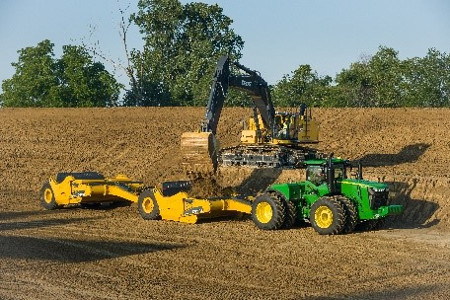 Tandem 2412D E being top-loaded
Tandem 2412D E being top-loaded
John Deere scrapers are designed to handle the harsh conditions of top-loading scrapers. The updated swept-back design to the top off the ejector wall provides a better, unobstructed bowl opening. Heavily shielded hydraulic lines, cylinders, and components provide protection when top loading needs arise. When conditions do not allow for direct loading, John Deere scraper systems can provide as much as 80 tons per cycle in top loading capacity with triples.
Top-loading produces a force caused by the weight of the material falling into the scraper. With the scraper sitting on the ground, this force travels into the ground through the frame of the scraper. If the scraper is in the raised position, the force could cause extreme hydraulic pressure spikes, which can severely damage the hydraulic system of the scraper tractor and scraper.
During top loading procedure, make sure the scraper blade is lowered and resting on the ground.
Top-loading scrapers in the raised position could void the scraper warranty.
Push loadable ejectors tackle the toughest conditions
All John Deere ejector scrapers are approved for push loading with a crawler
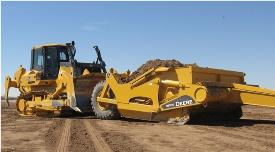 John Deere crawler pushes an ejector scraper
John Deere crawler pushes an ejector scraper
Sometimes, harsh conditions call for a little extra power. In the world of self-propelled scrapers, push loading with a crawler is a way of life.
While John Deere pull-type scrapers can direct load in almost any condition, the ability to push load has been built into the design of the ejector line to give earthmovers the additional versatility to which they are accustomed. Rock, hard pan, or heavy gumbos are just a few of the conditions where a crawler assist can keep the dirt moving.
Push loading is approved in single, tandem, and triple ejector trains where a rear scraper extended rear bumper is employed. The 2010D E and 2412D E two-tire models feature an integrated push block standard.
Automate water management with iGrade™ leveling system
Precision level custom land formations to better manage water
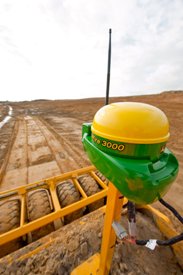 iGrade
iGrade
The iGrade controller enables and automates new water management applications, as well as John Deere's existing water management tool, Surface Water Pro™ Plus system. iGrade offers the ability to generate a basic plane and grade, as well as perform distance-based tasks – all while automatically controlling the height of the scraper blade.
iGrade provides four applications to complete different tasks:
- Surface Water Pro Plus automation
- Grade control
- Distance trip
- Plane control
The iGrade controller works with many of the different John Deere Precision Ag Technology components producers may already own, such as:
- GreenStar™ 2 2600 Display
- StarFire™ iTC receiver
- StarFire 3000 Receiver
- AutoTrac™ assisted steering system
- Surface Water Pro Plus
iGrade is approved for the following platforms:
- 9xxx, 8xxx, and 8R Series Wheel Tractors
- 8xxx and 8R Series Track Tractors
- Any selective control valve (SCV) operated water-management implement approved for the above John Deere tractors
NOTE: iGrade requires the receiver to have a real-time kinetic (RTK) signal level. iGrade does not support wide-area augmentation system (WAAS), SF1, or SF2 signal levels.
Versatile and productive in a number of applications
John Deere scraper systems in construction
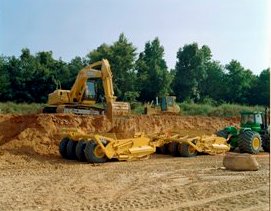 Top-loading large-scale commercial construction
Top-loading large-scale commercial construction
 Small-scale residential construction
Small-scale residential construction
In both large- and small-scale jobs for commercial and residential applications, John Deere scraper systems shine. From 41.3 m³ to 13.8 m³ (54 cu yd to 18 cu yd), with the pull of a pin, John Deere scrapers make it versatile enough for contractors who work in a broad range of job types.
John Deere scrapers are a valuable part of any construction fleet, whether as the primary mover or a complement to other equipment. Scrapers excavate, carry, spread, and grade material, making it the most efficient and versatile machine on any job site.
Agricultural applications
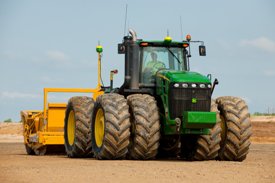 Precision leveling farm land with iGrade™ leveling system
Precision leveling farm land with iGrade™ leveling system
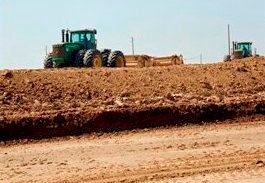 Levee construction
Levee construction
John Deere scraper systems are not just for precision laser land leveling. A sophisticated suite of precision agriculture products is offered, including iGrade for land leveling and Surface Water Pro™ Plus system for ditching and levee building.
The scrapers are also perfect for cattle feed lot maintenance, grain bin foundations, waterway topsoil reclamation, commercial ponds, and much more. Anywhere material needs to be moved, John Deere scrapers provide a solution that can excavate, carry, and grade material with one operator, one implement, and one tractor. This gives the grower or contractor a level of efficiency that cannot be achieved with most traditional construction equipment.
Mining applications
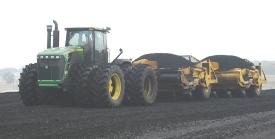 Scrapers hauling coal
Scrapers hauling coal
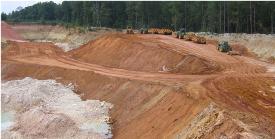 Stripping overburden
Stripping overburden
Just as contractors have adopted scrapers for their exemplary cost and productivity, miners look for greater efficiency when moving dirt or mined material. Scrapers are an excellent way to strip and reclaim overburden in pit mines or to simply haul stockpiled mined material such as coal.
John Deere scrapers are built to handle the most unique materials – nimble enough to handle light materials like coal yet rugged enough for heavier materials like wet sea salt.
Waste management applications
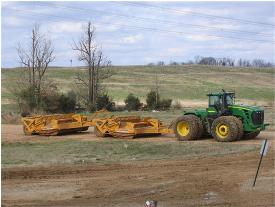 Building cells in a landfill
Building cells in a landfill
John Deere scraper systems are perfect for building and covering landfill cells in waste management applications. Waste management companies have experienced tremendous savings by trading in their trucks and excavators for the John Deere scraper system.
Scrapers not only do a great job of creating a cell, but their ability to spread material on grade make it ideal for covering waste. The gang of tires compact the material as it is unloaded and will not destroy haul roads. The scraper’s heavy-duty, rock-lug tires can handle the hazardous conditions found in a landfill. When heavy-garbage trucks deteriorate the offloading ramp, use the scraper blade to grade and rebuild it.
Features
Half the cost, half the investment - Save up to 50 cents per cu yd
Maximize productivity and minimize costs with the John Deere scraper system
Throughout the world, contractors have been moving material with conventional self-propelled scrapers or rigid/articulated trucks and excavators. John Deere scraper tractors and scrapers are a valuable solution for contractors, allowing them to move the same material using half the labor, half the investment, and saving 30 cents per cu yd to 50 cents per cu yd.
 9570RX Scraper Tractor and 2412D E Ejector Scraper
9570RX Scraper Tractor and 2412D E Ejector Scraper
 2412D E Ejector Scraper
2412D E Ejector Scraper
Half the labor
The John Deere scraper system is an independent earthmoving system requiring one operator to load, transport, and spread the materials on a job site. Self-propelled and truck/excavator earthmoving systems need additional support equipment to assist with loading and spreading the materials, increasing labor requirements.
Half the investment
Compare the purchase price of a John Deere scraper tractor and scrapers to competitive systems. Factor in the labor costs, fuel burn, daily operating expenses of all the equipment used in the system, and it all adds up to half the savings over the life of the equipment.
Saving 30 to 50 cents per cu yd
The savings are already adding up with the reduced labor requirements and lower investment costs. Experience additional savings from reduced fuel consumption by having only one tractor engine performing all of the work. Increase productivity moving more yards per cycle when using the 16-m3 or 18.3-m3 (21-cu yd or 24-cu yd) scrapers in tandem or triple configurations.
Applications for the John Deere scraper systems are as follows:
-
Residential development
-
Commercial development
-
Road construction
-
Mining/quarries
-
Levee construction
-
Reservoir construction
-
Airport construction
-
Precision leveling
AutoLoad™ system for smooth loading and efficient operation
 Manual loading (left) vs. AutoLoad (right)
Manual loading (left) vs. AutoLoad (right)
An innovation in the earthmoving industry exclusive to John Deere, the AutoLoad feature allows novice and experienced operators alike to be consistently productive while operating John Deere tractors and scrapers with the touch of a button, even if they have never operated tractors and scrapers.
Top-loading John Deere scrapers increase productivity for all applications
 Tandem 2412D E being top-loaded
Tandem 2412D E being top-loaded
John Deere scrapers are designed to handle the harsh conditions of top-loading scrapers. The updated swept-back design to the top off the ejector wall provides a better, unobstructed bowl opening. Heavily shielded hydraulic lines, cylinders, and components provide protection when top loading needs arise. When conditions do not allow for direct loading, John Deere scraper systems can provide as much as 80 tons per cycle in top loading capacity with triples.
Top-loading produces a force caused by the weight of the material falling into the scraper. With the scraper sitting on the ground, this force travels into the ground through the frame of the scraper. If the scraper is in the raised position, the force could cause extreme hydraulic pressure spikes, which can severely damage the hydraulic system of the scraper tractor and scraper.
During top loading procedure, make sure the scraper blade is lowered and resting on the ground.
Top-loading scrapers in the raised position could void the scraper warranty.
Push loadable ejectors tackle the toughest conditions
All John Deere ejector scrapers are approved for push loading with a crawler
 John Deere crawler pushes an ejector scraper
John Deere crawler pushes an ejector scraper
Sometimes, harsh conditions call for a little extra power. In the world of self-propelled scrapers, push loading with a crawler is a way of life.
While John Deere pull-type scrapers can direct load in almost any condition, the ability to push load has been built into the design of the ejector line to give earthmovers the additional versatility to which they are accustomed. Rock, hard pan, or heavy gumbos are just a few of the conditions where a crawler assist can keep the dirt moving.
Push loading is approved in single, tandem, and triple ejector trains where a rear scraper extended rear bumper is employed. The 2010D E and 2412D E two-tire models feature an integrated push block standard.
Automate water management with iGrade™ leveling system
Precision level custom land formations to better manage water
 iGrade
iGrade
The iGrade controller enables and automates new water management applications, as well as John Deere's existing water management tool, Surface Water Pro™ Plus system. iGrade offers the ability to generate a basic plane and grade, as well as perform distance-based tasks – all while automatically controlling the height of the scraper blade.
iGrade provides four applications to complete different tasks:
- Surface Water Pro Plus automation
- Grade control
- Distance trip
- Plane control
The iGrade controller works with many of the different John Deere Precision Ag Technology components producers may already own, such as:
- GreenStar™ 2 2600 Display
- StarFire™ iTC receiver
- StarFire 3000 Receiver
- AutoTrac™ assisted steering system
- Surface Water Pro Plus
iGrade is approved for the following platforms:
- 9xxx, 8xxx, and 8R Series Wheel Tractors
- 8xxx and 8R Series Track Tractors
- Any selective control valve (SCV) operated water-management implement approved for the above John Deere tractors
NOTE: iGrade requires the receiver to have a real-time kinetic (RTK) signal level. iGrade does not support wide-area augmentation system (WAAS), SF1, or SF2 signal levels.
Versatile and productive in a number of applications
John Deere scraper systems in construction
 Top-loading large-scale commercial construction
Top-loading large-scale commercial construction
 Small-scale residential construction
Small-scale residential construction
In both large- and small-scale jobs for commercial and residential applications, John Deere scraper systems shine. From 41.3 m³ to 13.8 m³ (54 cu yd to 18 cu yd), with the pull of a pin, John Deere scrapers make it versatile enough for contractors who work in a broad range of job types.
John Deere scrapers are a valuable part of any construction fleet, whether as the primary mover or a complement to other equipment. Scrapers excavate, carry, spread, and grade material, making it the most efficient and versatile machine on any job site.
Agricultural applications
 Precision leveling farm land with iGrade™ leveling system
Precision leveling farm land with iGrade™ leveling system
 Levee construction
Levee construction
John Deere scraper systems are not just for precision laser land leveling. A sophisticated suite of precision agriculture products is offered, including iGrade for land leveling and Surface Water Pro™ Plus system for ditching and levee building.
The scrapers are also perfect for cattle feed lot maintenance, grain bin foundations, waterway topsoil reclamation, commercial ponds, and much more. Anywhere material needs to be moved, John Deere scrapers provide a solution that can excavate, carry, and grade material with one operator, one implement, and one tractor. This gives the grower or contractor a level of efficiency that cannot be achieved with most traditional construction equipment.
Mining applications
 Scrapers hauling coal
Scrapers hauling coal
 Stripping overburden
Stripping overburden
Just as contractors have adopted scrapers for their exemplary cost and productivity, miners look for greater efficiency when moving dirt or mined material. Scrapers are an excellent way to strip and reclaim overburden in pit mines or to simply haul stockpiled mined material such as coal.
John Deere scrapers are built to handle the most unique materials – nimble enough to handle light materials like coal yet rugged enough for heavier materials like wet sea salt.
Waste management applications
 Building cells in a landfill
Building cells in a landfill
John Deere scraper systems are perfect for building and covering landfill cells in waste management applications. Waste management companies have experienced tremendous savings by trading in their trucks and excavators for the John Deere scraper system.
Scrapers not only do a great job of creating a cell, but their ability to spread material on grade make it ideal for covering waste. The gang of tires compact the material as it is unloaded and will not destroy haul roads. The scraper’s heavy-duty, rock-lug tires can handle the hazardous conditions found in a landfill. When heavy-garbage trucks deteriorate the offloading ramp, use the scraper blade to grade and rebuild it.
Features
Half the cost, half the investment - Save up to 50 cents per cu yd
Maximize productivity and minimize costs with the John Deere scraper system
Throughout the world, contractors have been moving material with conventional self-propelled scrapers or rigid/articulated trucks and excavators. John Deere scraper tractors and scrapers are a valuable solution for contractors, allowing them to move the same material using half the labor, half the investment, and saving 30 cents per cu yd to 50 cents per cu yd.
 9570RX Scraper Tractor and 2412D E Ejector Scraper
9570RX Scraper Tractor and 2412D E Ejector Scraper
 2412D E Ejector Scraper
2412D E Ejector Scraper
Half the labor
The John Deere scraper system is an independent earthmoving system requiring one operator to load, transport, and spread the materials on a job site. Self-propelled and truck/excavator earthmoving systems need additional support equipment to assist with loading and spreading the materials, increasing labor requirements.
Half the investment
Compare the purchase price of a John Deere scraper tractor and scrapers to competitive systems. Factor in the labor costs, fuel burn, daily operating expenses of all the equipment used in the system, and it all adds up to half the savings over the life of the equipment.
Saving 30 to 50 cents per cu yd
The savings are already adding up with the reduced labor requirements and lower investment costs. Experience additional savings from reduced fuel consumption by having only one tractor engine performing all of the work. Increase productivity moving more yards per cycle when using the 16-m3 or 18.3-m3 (21-cu yd or 24-cu yd) scrapers in tandem or triple configurations.
Applications for the John Deere scraper systems are as follows:
-
Residential development
-
Commercial development
-
Road construction
-
Mining/quarries
-
Levee construction
-
Reservoir construction
-
Airport construction
-
Precision leveling
AutoLoad™ system for smooth loading and efficient operation
 Manual loading (left) vs. AutoLoad (right)
Manual loading (left) vs. AutoLoad (right)
An innovation in the earthmoving industry exclusive to John Deere, the AutoLoad feature allows novice and experienced operators alike to be consistently productive while operating John Deere tractors and scrapers with the touch of a button, even if they have never operated tractors and scrapers.
Top-loading John Deere scrapers increase productivity for all applications
 Tandem 2412D E being top-loaded
Tandem 2412D E being top-loaded
John Deere scrapers are designed to handle the harsh conditions of top-loading scrapers. The updated swept-back design to the top off the ejector wall provides a better, unobstructed bowl opening. Heavily shielded hydraulic lines, cylinders, and components provide protection when top loading needs arise. When conditions do not allow for direct loading, John Deere scraper systems can provide as much as 80 tons per cycle in top loading capacity with triples.
Top-loading produces a force caused by the weight of the material falling into the scraper. With the scraper sitting on the ground, this force travels into the ground through the frame of the scraper. If the scraper is in the raised position, the force could cause extreme hydraulic pressure spikes, which can severely damage the hydraulic system of the scraper tractor and scraper.
During top loading procedure, make sure the scraper blade is lowered and resting on the ground.
Top-loading scrapers in the raised position could void the scraper warranty.
Push loadable ejectors tackle the toughest conditions
All John Deere ejector scrapers are approved for push loading with a crawler
 John Deere crawler pushes an ejector scraper
John Deere crawler pushes an ejector scraper
Sometimes, harsh conditions call for a little extra power. In the world of self-propelled scrapers, push loading with a crawler is a way of life.
While John Deere pull-type scrapers can direct load in almost any condition, the ability to push load has been built into the design of the ejector line to give earthmovers the additional versatility to which they are accustomed. Rock, hard pan, or heavy gumbos are just a few of the conditions where a crawler assist can keep the dirt moving.
Push loading is approved in single, tandem, and triple ejector trains where a rear scraper extended rear bumper is employed. The 2010D E and 2412D E two-tire models feature an integrated push block standard.
Automate water management with iGrade™ leveling system
Precision level custom land formations to better manage water
 iGrade
iGrade
The iGrade controller enables and automates new water management applications, as well as John Deere's existing water management tool, Surface Water Pro™ Plus system. iGrade offers the ability to generate a basic plane and grade, as well as perform distance-based tasks – all while automatically controlling the height of the scraper blade.
iGrade provides four applications to complete different tasks:
- Surface Water Pro Plus automation
- Grade control
- Distance trip
- Plane control
The iGrade controller works with many of the different John Deere Precision Ag Technology components producers may already own, such as:
- GreenStar™ 2 2600 Display
- StarFire™ iTC receiver
- StarFire 3000 Receiver
- AutoTrac™ assisted steering system
- Surface Water Pro Plus
iGrade is approved for the following platforms:
- 9xxx, 8xxx, and 8R Series Wheel Tractors
- 8xxx and 8R Series Track Tractors
- Any selective control valve (SCV) operated water-management implement approved for the above John Deere tractors
NOTE: iGrade requires the receiver to have a real-time kinetic (RTK) signal level. iGrade does not support wide-area augmentation system (WAAS), SF1, or SF2 signal levels.
Versatile and productive in a number of applications
John Deere scraper systems in construction
 Top-loading large-scale commercial construction
Top-loading large-scale commercial construction
 Small-scale residential construction
Small-scale residential construction
In both large- and small-scale jobs for commercial and residential applications, John Deere scraper systems shine. From 41.3 m³ to 13.8 m³ (54 cu yd to 18 cu yd), with the pull of a pin, John Deere scrapers make it versatile enough for contractors who work in a broad range of job types.
John Deere scrapers are a valuable part of any construction fleet, whether as the primary mover or a complement to other equipment. Scrapers excavate, carry, spread, and grade material, making it the most efficient and versatile machine on any job site.
Agricultural applications
 Precision leveling farm land with iGrade™ leveling system
Precision leveling farm land with iGrade™ leveling system
 Levee construction
Levee construction
John Deere scraper systems are not just for precision laser land leveling. A sophisticated suite of precision agriculture products is offered, including iGrade for land leveling and Surface Water Pro™ Plus system for ditching and levee building.
The scrapers are also perfect for cattle feed lot maintenance, grain bin foundations, waterway topsoil reclamation, commercial ponds, and much more. Anywhere material needs to be moved, John Deere scrapers provide a solution that can excavate, carry, and grade material with one operator, one implement, and one tractor. This gives the grower or contractor a level of efficiency that cannot be achieved with most traditional construction equipment.
Mining applications
 Scrapers hauling coal
Scrapers hauling coal
 Stripping overburden
Stripping overburden
Just as contractors have adopted scrapers for their exemplary cost and productivity, miners look for greater efficiency when moving dirt or mined material. Scrapers are an excellent way to strip and reclaim overburden in pit mines or to simply haul stockpiled mined material such as coal.
John Deere scrapers are built to handle the most unique materials – nimble enough to handle light materials like coal yet rugged enough for heavier materials like wet sea salt.
Waste management applications
 Building cells in a landfill
Building cells in a landfill
John Deere scraper systems are perfect for building and covering landfill cells in waste management applications. Waste management companies have experienced tremendous savings by trading in their trucks and excavators for the John Deere scraper system.
Scrapers not only do a great job of creating a cell, but their ability to spread material on grade make it ideal for covering waste. The gang of tires compact the material as it is unloaded and will not destroy haul roads. The scraper’s heavy-duty, rock-lug tires can handle the hazardous conditions found in a landfill. When heavy-garbage trucks deteriorate the offloading ramp, use the scraper blade to grade and rebuild it.
Features
Half the cost, half the investment - Save up to 50 cents per cu yd
Maximize productivity and minimize costs with the John Deere scraper system
Throughout the world, contractors have been moving material with conventional self-propelled scrapers or rigid/articulated trucks and excavators. John Deere scraper tractors and scrapers are a valuable solution for contractors, allowing them to move the same material using half the labor, half the investment, and saving 30 cents per cu yd to 50 cents per cu yd.
 9570RX Scraper Tractor and 2412D E Ejector Scraper
9570RX Scraper Tractor and 2412D E Ejector Scraper
 2412D E Ejector Scraper
2412D E Ejector Scraper
Half the labor
The John Deere scraper system is an independent earthmoving system requiring one operator to load, transport, and spread the materials on a job site. Self-propelled and truck/excavator earthmoving systems need additional support equipment to assist with loading and spreading the materials, increasing labor requirements.
Half the investment
Compare the purchase price of a John Deere scraper tractor and scrapers to competitive systems. Factor in the labor costs, fuel burn, daily operating expenses of all the equipment used in the system, and it all adds up to half the savings over the life of the equipment.
Saving 30 to 50 cents per cu yd
The savings are already adding up with the reduced labor requirements and lower investment costs. Experience additional savings from reduced fuel consumption by having only one tractor engine performing all of the work. Increase productivity moving more yards per cycle when using the 16-m3 or 18.3-m3 (21-cu yd or 24-cu yd) scrapers in tandem or triple configurations.
Applications for the John Deere scraper systems are as follows:
-
Residential development
-
Commercial development
-
Road construction
-
Mining/quarries
-
Levee construction
-
Reservoir construction
-
Airport construction
-
Precision leveling
Top-loading John Deere scrapers increase productivity for all applications
 Tandem 2412D E being top-loaded
Tandem 2412D E being top-loaded
John Deere scrapers are designed to handle the harsh conditions of top-loading scrapers. The updated swept-back design to the top off the ejector wall provides a better, unobstructed bowl opening. Heavily shielded hydraulic lines, cylinders, and components provide protection when top loading needs arise. When conditions do not allow for direct loading, John Deere scraper systems can provide as much as 80 tons per cycle in top loading capacity with triples.
Top-loading produces a force caused by the weight of the material falling into the scraper. With the scraper sitting on the ground, this force travels into the ground through the frame of the scraper. If the scraper is in the raised position, the force could cause extreme hydraulic pressure spikes, which can severely damage the hydraulic system of the scraper tractor and scraper.
During top loading procedure, make sure the scraper blade is lowered and resting on the ground.
Top-loading scrapers in the raised position could void the scraper warranty.
AutoLoad™ system for smooth loading and efficient operation
 Manual loading (left) vs. AutoLoad (right)
Manual loading (left) vs. AutoLoad (right)
An innovation in the earthmoving industry exclusive to John Deere, the AutoLoad feature allows novice and experienced operators alike to be consistently productive while operating John Deere tractors and scrapers with the touch of a button, even if they have never operated tractors and scrapers.
Push loadable ejectors tackle the toughest conditions
All John Deere ejector scrapers are approved for push loading with a crawler
 John Deere crawler pushes an ejector scraper
John Deere crawler pushes an ejector scraper
Sometimes, harsh conditions call for a little extra power. In the world of self-propelled scrapers, push loading with a crawler is a way of life.
While John Deere pull-type scrapers can direct load in almost any condition, the ability to push load has been built into the design of the ejector line to give earthmovers the additional versatility to which they are accustomed. Rock, hard pan, or heavy gumbos are just a few of the conditions where a crawler assist can keep the dirt moving.
Push loading is approved in single, tandem, and triple ejector trains where a rear scraper extended rear bumper is employed. The 2010D E and 2412D E two-tire models feature an integrated push block standard.
Automate water management with iGrade™ leveling system
Precision level custom land formations to better manage water
 iGrade
iGrade
The iGrade controller enables and automates new water management applications, as well as John Deere's existing water management tool, Surface Water Pro™ Plus system. iGrade offers the ability to generate a basic plane and grade, as well as perform distance-based tasks – all while automatically controlling the height of the scraper blade.
iGrade provides four applications to complete different tasks:
- Surface Water Pro Plus automation
- Grade control
- Distance trip
- Plane control
The iGrade controller works with many of the different John Deere Precision Ag Technology components producers may already own, such as:
- GreenStar™ 2 2600 Display
- StarFire™ iTC receiver
- StarFire 3000 Receiver
- AutoTrac™ assisted steering system
- Surface Water Pro Plus
iGrade is approved for the following platforms:
- 9xxx, 8xxx, and 8R Series Wheel Tractors
- 8xxx and 8R Series Track Tractors
- Any selective control valve (SCV) operated water-management implement approved for the above John Deere tractors
NOTE: iGrade requires the receiver to have a real-time kinetic (RTK) signal level. iGrade does not support wide-area augmentation system (WAAS), SF1, or SF2 signal levels.
Versatile and productive in a number of applications
John Deere scraper systems in construction
 Top-loading large-scale commercial construction
Top-loading large-scale commercial construction
 Small-scale residential construction
Small-scale residential construction
In both large- and small-scale jobs for commercial and residential applications, John Deere scraper systems shine. From 41.3 m³ to 13.8 m³ (54 cu yd to 18 cu yd), with the pull of a pin, John Deere scrapers make it versatile enough for contractors who work in a broad range of job types.
John Deere scrapers are a valuable part of any construction fleet, whether as the primary mover or a complement to other equipment. Scrapers excavate, carry, spread, and grade material, making it the most efficient and versatile machine on any job site.
Agricultural applications
 Precision leveling farm land with iGrade™ leveling system
Precision leveling farm land with iGrade™ leveling system
 Levee construction
Levee construction
John Deere scraper systems are not just for precision laser land leveling. A sophisticated suite of precision agriculture products is offered, including iGrade for land leveling and Surface Water Pro™ Plus system for ditching and levee building.
The scrapers are also perfect for cattle feed lot maintenance, grain bin foundations, waterway topsoil reclamation, commercial ponds, and much more. Anywhere material needs to be moved, John Deere scrapers provide a solution that can excavate, carry, and grade material with one operator, one implement, and one tractor. This gives the grower or contractor a level of efficiency that cannot be achieved with most traditional construction equipment.
Mining applications
 Scrapers hauling coal
Scrapers hauling coal
 Stripping overburden
Stripping overburden
Just as contractors have adopted scrapers for their exemplary cost and productivity, miners look for greater efficiency when moving dirt or mined material. Scrapers are an excellent way to strip and reclaim overburden in pit mines or to simply haul stockpiled mined material such as coal.
John Deere scrapers are built to handle the most unique materials – nimble enough to handle light materials like coal yet rugged enough for heavier materials like wet sea salt.
Waste management applications
 Building cells in a landfill
Building cells in a landfill
John Deere scraper systems are perfect for building and covering landfill cells in waste management applications. Waste management companies have experienced tremendous savings by trading in their trucks and excavators for the John Deere scraper system.
Scrapers not only do a great job of creating a cell, but their ability to spread material on grade make it ideal for covering waste. The gang of tires compact the material as it is unloaded and will not destroy haul roads. The scraper’s heavy-duty, rock-lug tires can handle the hazardous conditions found in a landfill. When heavy-garbage trucks deteriorate the offloading ramp, use the scraper blade to grade and rebuild it.
Features
AutoLoad™ for smooth loading and efficient operation
 Manual loading (left) vs. AutoLoad (right)
Manual loading (left) vs. AutoLoad (right)
An innovation in the earthmoving industry exclusive to John Deere, the AutoLoad feature allows novice and experienced operators alike to be consistently productive while operating John Deere tractors and scrapers with the touch of a button, even if they have never operated tractors and scrapers before. AutoLoad is now easier than ever with the new set up wizard featured on 9R Series Scraper Specials.
Automate water management with iGrade™
Precision level custom land formations to better manage water
 iGrade
iGrade

The iGrade controller enables and automates new water management applications, as well as John Deere's existing water management tool, Surface Water Pro™ Plus. iGrade offers the ability to generate a basic plane and grade, as well as perform distance-based tasks – all while automatically controlling the height of the scraper blade.
iGrade provides four applications to complete different tasks:
- Surface Water Pro Plus automation
- Grade control
- Distance trip
- Plane control
The iGrade controller works with many of the different John Deere Ag Management Solutions (AMS) components producers may already own, such as:
- GreenStar™ 3 (GS3) 2630 Display
- GreenStar 2 (GS2) 2600 Display
- StarFire™ iTC receiver
- StarFire 3000 Receiver
- AutoTrac™
- Surface Water Pro Plus
iGrade is approved for the following platforms:
- 9 and 8 Family Wheel Tractors
- 9 and 8 Family Track Tractors
- Any selective control valve (SCV) operated water-management implement approved for the above John Deere tractors
NOTE: iGrade requires the receiver to have an real-time kinetic (RTK) signal level. iGrade does not support wide area augmentation system (WAAS), EGNOS, SF1, or SF2 signal levels. The John Deere Application Controller is required for iGrade activation.
Versatile and productive in a number of applications
John Deere scraper systems in construction
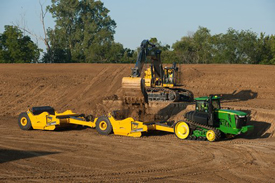 Top-loading large-scale commercial construction
Top-loading large-scale commercial construction

In both large- and small-scale jobs for commercial and residential applications, John Deere scraper systems shine. With capacities ranging from 11.5 to 18.3 m³(15 to 24 cu yd) and single cycle payloads of up to 55 m³ (72 cu yd), John Deere scrapers are versatile enough for contractors who work in a broad range of job types. John Deere scrapers really shine in highway construction and other infrastructure development projects where long cuts and fills at high volumes are common.
John Deere scrapers are a valuable part of any construction fleet, whether as the primary mover or a complement to other equipment. Scrapers excavate, carry, spread, and grade material, making it the most efficient and versatile machine on any job site.
Agricultural applications
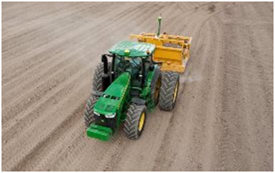 Precision leveling farm land with iGrade™
Precision leveling farm land with iGrade™

John Deere scraper systems are not just for precision land leveling. A sophisticated suite of precision agriculture products are offered, including iGrade for land leveling and Surface Water Pro™ Plus for ditching and levee building.
The scrapers are also perfect for cattle feed lot maintenance, grain bin foundations, waterway topsoil reclamation, commercial ponds, and much more. Anywhere material needs to be moved, John Deere scrapers provide a solution that can excavate, carry, and grade material with one operator, one implement, and one tractor. This gives the grower or contractor a level of efficiency that cannot be achieved with most traditional construction equipment.
Mining applications
 Scrapers hauling coal
Scrapers hauling coal
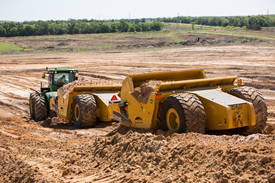 Stripping overburden
Stripping overburden
Just as contractors have adopted scrapers for their exemplary cost and productivity, miners look for greater efficiency when moving dirt or mined material. Scrapers are an excellent way to strip and reclaim overburden in pit mines or to simply haul stockpiled mined material such as coal.
John Deere scrapers are built to handle the most unique materials – nimble enough to handle light materials like coal yet rugged enough for heavier materials like wet sea salt.
Waste management applications
 Descending a landfill with a single ejector
Descending a landfill with a single ejector

John Deere scraper systems are perfect for building and covering landfill cells in waste management applications. Waste management companies have experienced tremendous savings by trading in their trucks and excavators for the John Deere scraper system.
Scrapers not only do a great job of creating a cell, but their ability to spread material on grade make it ideal for covering waste. The gang of tires compact the material as it is unloaded and will not prematurely degrade haul roads. The scraper’s heavy-duty, rock-lug tires can handle the hazardous conditions found in a landfill. When heavy-garbage trucks deteriorate the offloading ramp, use the scraper blade to grade and rebuild it.
Half the labor, one-third the investment - Save up to 50 cents per cu yd
Maximize productivity, minimize costs with the John Deere scraper system
Throughout the world, contractors have been moving material with self-propelled scrapers or rigid/articulated trucks and excavators. John Deere scraper tractors and scrapers are a valuable solution for contractors, allowing them to move the same material as they did with conventional earthmoving systems, but using only half the labor, one-third the investment, for savings of up to 50 cents per cubic yard.
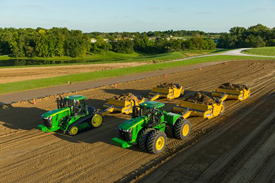 The John Deere scraper system
The John Deere scraper system

Half the labor
The John Deere scraper system is an independent earthmoving system requiring one operator to load, transport, and spread material to grade on a job site. Self-propelled scraper and truck/excavator earthmoving systems need additional support equipment to assist with loading and spreading the materials, increasing labor requirements.
One-third the investment
Compare the purchase price of a John Deere scraper tractor and scrapers to competitive systems. Factor in the labor costs, fuel burn, daily operating expenses of all the equipment used in the system, and it all adds up to about one-third the savings over the life of the equipment.
Saving up to 50 cents per cubic yard
The savings are already adding up with the reduced labor requirements and lower investment costs. Experience additional savings from reduced fuel consumption by having only one tractor engine performing all of the work. Now increase productivity moving more yards per cycle with up to 72 cubic yards in triple configurations.
Some common applications for the John Deere scraper systems are as follows:
- Residential or commercial site preparation
- Highway and infrastructure development
- Mining or quarrying
- Levee and reservoir construction
- Precision leveling and water management practices
- Waste management
Top-loading John Deere scrapers increase productivity for all applications
 Top loading the 2412D E
Top loading the 2412D E

John Deere scrapers are designed to handle the harsh conditions of top-loading scrapers. A wide, unobstructed bowl opening and heavily shielded hydraulic lines, cylinders, and components provide a nice target for large excavator buckets. In fact, D Series ejectors feature a swept back overflow spill guard that increases the top loading target by 24% over previous models. When conditions do not allow for direct loading, John Deere scraper systems can provide as much as 72 cubic yards per cycle in top loading capacity with triples.
Top-loading produces a force caused by the weight of the material falling into the scraper. With the scraper sitting on the ground, this force travels into the ground through the frame of the scraper. If the scraper is in the raised position, the force could cause extreme hydraulic pressure spikes, which can severely damage the hydraulic system of the scraper tractor and scraper. During top loading procedure, make sure the scraper blade is lowered and resting on the ground. Top-loading scrapers in the raised position could void the scraper warranty.
Features
AutoLoad™ for smooth loading and efficient operation
 Manual loading (left) vs. AutoLoad (right)
Manual loading (left) vs. AutoLoad (right)
An innovation in the earthmoving industry exclusive to John Deere, the AutoLoad feature allows novice and experienced operators alike to be consistently productive while operating John Deere tractors and scrapers with the touch of a button, even if they have never operated tractors and scrapers before. AutoLoad is now easier than ever with the new set up wizard featured on 9R Series Scraper Specials.
Automate water management with iGrade™
Precision level custom land formations to better manage water
 iGrade
iGrade

The iGrade controller enables and automates new water management applications, as well as John Deere's existing water management tool, Surface Water Pro™ Plus. iGrade offers the ability to generate a basic plane and grade, as well as perform distance-based tasks – all while automatically controlling the height of the scraper blade.
iGrade provides four applications to complete different tasks:
- Surface Water Pro Plus automation
- Grade control
- Distance trip
- Plane control
The iGrade controller works with many of the different John Deere Ag Management Solutions (AMS) components producers may already own, such as:
- GreenStar™ 3 (GS3) 2630 Display
- GreenStar 2 (GS2) 2600 Display
- StarFire™ iTC receiver
- StarFire 3000 Receiver
- AutoTrac™
- Surface Water Pro Plus
iGrade is approved for the following platforms:
- 9 and 8 Family Wheel Tractors
- 9 and 8 Family Track Tractors
- Any selective control valve (SCV) operated water-management implement approved for the above John Deere tractors
NOTE: iGrade requires the receiver to have an real-time kinetic (RTK) signal level. iGrade does not support wide area augmentation system (WAAS), EGNOS, SF1, or SF2 signal levels. The John Deere Application Controller is required for iGrade activation.
Versatile and productive in a number of applications
John Deere scraper systems in construction
 Top-loading large-scale commercial construction
Top-loading large-scale commercial construction

In both large- and small-scale jobs for commercial and residential applications, John Deere scraper systems shine. With capacities ranging from 11.5 to 18.3 m³(15 to 24 cu yd) and single cycle payloads of up to 55 m³ (72 cu yd), John Deere scrapers are versatile enough for contractors who work in a broad range of job types. John Deere scrapers really shine in highway construction and other infrastructure development projects where long cuts and fills at high volumes are common.
John Deere scrapers are a valuable part of any construction fleet, whether as the primary mover or a complement to other equipment. Scrapers excavate, carry, spread, and grade material, making it the most efficient and versatile machine on any job site.
Agricultural applications
 Precision leveling farm land with iGrade™
Precision leveling farm land with iGrade™

John Deere scraper systems are not just for precision land leveling. A sophisticated suite of precision agriculture products are offered, including iGrade for land leveling and Surface Water Pro™ Plus for ditching and levee building.
The scrapers are also perfect for cattle feed lot maintenance, grain bin foundations, waterway topsoil reclamation, commercial ponds, and much more. Anywhere material needs to be moved, John Deere scrapers provide a solution that can excavate, carry, and grade material with one operator, one implement, and one tractor. This gives the grower or contractor a level of efficiency that cannot be achieved with most traditional construction equipment.
Mining applications
 Scrapers hauling coal
Scrapers hauling coal
 Stripping overburden
Stripping overburden
Just as contractors have adopted scrapers for their exemplary cost and productivity, miners look for greater efficiency when moving dirt or mined material. Scrapers are an excellent way to strip and reclaim overburden in pit mines or to simply haul stockpiled mined material such as coal.
John Deere scrapers are built to handle the most unique materials – nimble enough to handle light materials like coal yet rugged enough for heavier materials like wet sea salt.
Waste management applications
 Descending a landfill with a single ejector
Descending a landfill with a single ejector

John Deere scraper systems are perfect for building and covering landfill cells in waste management applications. Waste management companies have experienced tremendous savings by trading in their trucks and excavators for the John Deere scraper system.
Scrapers not only do a great job of creating a cell, but their ability to spread material on grade make it ideal for covering waste. The gang of tires compact the material as it is unloaded and will not prematurely degrade haul roads. The scraper’s heavy-duty, rock-lug tires can handle the hazardous conditions found in a landfill. When heavy-garbage trucks deteriorate the offloading ramp, use the scraper blade to grade and rebuild it.
Half the labor, one-third the investment - Save up to 50 cents per cu yd
Maximize productivity, minimize costs with the John Deere scraper system
Throughout the world, contractors have been moving material with self-propelled scrapers or rigid/articulated trucks and excavators. John Deere scraper tractors and scrapers are a valuable solution for contractors, allowing them to move the same material as they did with conventional earthmoving systems, but using only half the labor, one-third the investment, for savings of up to 50 cents per cubic yard.
 The John Deere scraper system
The John Deere scraper system

Half the labor
The John Deere scraper system is an independent earthmoving system requiring one operator to load, transport, and spread material to grade on a job site. Self-propelled scraper and truck/excavator earthmoving systems need additional support equipment to assist with loading and spreading the materials, increasing labor requirements.
One-third the investment
Compare the purchase price of a John Deere scraper tractor and scrapers to competitive systems. Factor in the labor costs, fuel burn, daily operating expenses of all the equipment used in the system, and it all adds up to about one-third the savings over the life of the equipment.
Saving up to 50 cents per cubic yard
The savings are already adding up with the reduced labor requirements and lower investment costs. Experience additional savings from reduced fuel consumption by having only one tractor engine performing all of the work. Now increase productivity moving more yards per cycle with up to 72 cubic yards in triple configurations.
Some common applications for the John Deere scraper systems are as follows:
- Residential or commercial site preparation
- Highway and infrastructure development
- Mining or quarrying
- Levee and reservoir construction
- Precision leveling and water management practices
- Waste management
Top-loading John Deere scrapers increase productivity for all applications
 Top loading the 2412D E
Top loading the 2412D E

John Deere scrapers are designed to handle the harsh conditions of top-loading scrapers. A wide, unobstructed bowl opening and heavily shielded hydraulic lines, cylinders, and components provide a nice target for large excavator buckets. In fact, D Series ejectors feature a swept back overflow spill guard that increases the top loading target by 24% over previous models. When conditions do not allow for direct loading, John Deere scraper systems can provide as much as 72 cubic yards per cycle in top loading capacity with triples.
Top-loading produces a force caused by the weight of the material falling into the scraper. With the scraper sitting on the ground, this force travels into the ground through the frame of the scraper. If the scraper is in the raised position, the force could cause extreme hydraulic pressure spikes, which can severely damage the hydraulic system of the scraper tractor and scraper. During top loading procedure, make sure the scraper blade is lowered and resting on the ground. Top-loading scrapers in the raised position could void the scraper warranty.
Features
AutoLoad™ for smooth loading and efficient operation
 Manual loading (left) vs. AutoLoad (right)
Manual loading (left) vs. AutoLoad (right)
An innovation in the earthmoving industry exclusive to John Deere, the AutoLoad feature allows novice and experienced operators alike to be consistently productive while operating John Deere tractors and scrapers with the touch of a button, even if they have never operated tractors and scrapers before. AutoLoad is now easier than ever with the new set up wizard featured on 9R Series Scraper Specials.
Automate water management with iGrade™
Precision level custom land formations to better manage water
 iGrade
iGrade

The iGrade controller enables and automates new water management applications, as well as John Deere's existing water management tool, Surface Water Pro™ Plus. iGrade offers the ability to generate a basic plane and grade, as well as perform distance-based tasks – all while automatically controlling the height of the scraper blade.
iGrade provides four applications to complete different tasks:
- Surface Water Pro Plus automation
- Grade control
- Distance trip
- Plane control
The iGrade controller works with many of the different John Deere Ag Management Solutions (AMS) components producers may already own, such as:
- GreenStar™ 3 (GS3) 2630 Display
- GreenStar 2 (GS2) 2600 Display
- StarFire™ iTC receiver
- StarFire 3000 Receiver
- AutoTrac™
- Surface Water Pro Plus
iGrade is approved for the following platforms:
- 9 and 8 Family Wheel Tractors
- 9 and 8 Family Track Tractors
- Any selective control valve (SCV) operated water-management implement approved for the above John Deere tractors
NOTE: iGrade requires the receiver to have an real-time kinetic (RTK) signal level. iGrade does not support wide area augmentation system (WAAS), EGNOS, SF1, or SF2 signal levels. The John Deere Application Controller is required for iGrade activation.
Versatile and productive in a number of applications
John Deere scraper systems in construction
 Top-loading large-scale commercial construction
Top-loading large-scale commercial construction

In both large- and small-scale jobs for commercial and residential applications, John Deere scraper systems shine. With capacities ranging from 11.5 to 18.3 m³(15 to 24 cu yd) and single cycle payloads of up to 55 m³ (72 cu yd), John Deere scrapers are versatile enough for contractors who work in a broad range of job types. John Deere scrapers really shine in highway construction and other infrastructure development projects where long cuts and fills at high volumes are common.
John Deere scrapers are a valuable part of any construction fleet, whether as the primary mover or a complement to other equipment. Scrapers excavate, carry, spread, and grade material, making it the most efficient and versatile machine on any job site.
Agricultural applications
 Precision leveling farm land with iGrade™
Precision leveling farm land with iGrade™

John Deere scraper systems are not just for precision land leveling. A sophisticated suite of precision agriculture products are offered, including iGrade for land leveling and Surface Water Pro™ Plus for ditching and levee building.
The scrapers are also perfect for cattle feed lot maintenance, grain bin foundations, waterway topsoil reclamation, commercial ponds, and much more. Anywhere material needs to be moved, John Deere scrapers provide a solution that can excavate, carry, and grade material with one operator, one implement, and one tractor. This gives the grower or contractor a level of efficiency that cannot be achieved with most traditional construction equipment.
Mining applications
 Scrapers hauling coal
Scrapers hauling coal
 Stripping overburden
Stripping overburden
Just as contractors have adopted scrapers for their exemplary cost and productivity, miners look for greater efficiency when moving dirt or mined material. Scrapers are an excellent way to strip and reclaim overburden in pit mines or to simply haul stockpiled mined material such as coal.
John Deere scrapers are built to handle the most unique materials – nimble enough to handle light materials like coal yet rugged enough for heavier materials like wet sea salt.
Waste management applications
 Descending a landfill with a single ejector
Descending a landfill with a single ejector

John Deere scraper systems are perfect for building and covering landfill cells in waste management applications. Waste management companies have experienced tremendous savings by trading in their trucks and excavators for the John Deere scraper system.
Scrapers not only do a great job of creating a cell, but their ability to spread material on grade make it ideal for covering waste. The gang of tires compact the material as it is unloaded and will not prematurely degrade haul roads. The scraper’s heavy-duty, rock-lug tires can handle the hazardous conditions found in a landfill. When heavy-garbage trucks deteriorate the offloading ramp, use the scraper blade to grade and rebuild it.
Half the labor, one-third the investment - Save up to 50 cents per cu yd
Maximize productivity, minimize costs with the John Deere scraper system
Throughout the world, contractors have been moving material with self-propelled scrapers or rigid/articulated trucks and excavators. John Deere scraper tractors and scrapers are a valuable solution for contractors, allowing them to move the same material as they did with conventional earthmoving systems, but using only half the labor, one-third the investment, for savings of up to 50 cents per cubic yard.
 The John Deere scraper system
The John Deere scraper system

Half the labor
The John Deere scraper system is an independent earthmoving system requiring one operator to load, transport, and spread material to grade on a job site. Self-propelled scraper and truck/excavator earthmoving systems need additional support equipment to assist with loading and spreading the materials, increasing labor requirements.
One-third the investment
Compare the purchase price of a John Deere scraper tractor and scrapers to competitive systems. Factor in the labor costs, fuel burn, daily operating expenses of all the equipment used in the system, and it all adds up to about one-third the savings over the life of the equipment.
Saving up to 50 cents per cubic yard
The savings are already adding up with the reduced labor requirements and lower investment costs. Experience additional savings from reduced fuel consumption by having only one tractor engine performing all of the work. Now increase productivity moving more yards per cycle with up to 72 cubic yards in triple configurations.
Some common applications for the John Deere scraper systems are as follows:
- Residential or commercial site preparation
- Highway and infrastructure development
- Mining or quarrying
- Levee and reservoir construction
- Precision leveling and water management practices
- Waste management
Top-loading John Deere scrapers increase productivity for all applications
 Top loading the 2412D E
Top loading the 2412D E

John Deere scrapers are designed to handle the harsh conditions of top-loading scrapers. A wide, unobstructed bowl opening and heavily shielded hydraulic lines, cylinders, and components provide a nice target for large excavator buckets. In fact, D Series ejectors feature a swept back overflow spill guard that increases the top loading target by 24% over previous models. When conditions do not allow for direct loading, John Deere scraper systems can provide as much as 72 cubic yards per cycle in top loading capacity with triples.
Top-loading produces a force caused by the weight of the material falling into the scraper. With the scraper sitting on the ground, this force travels into the ground through the frame of the scraper. If the scraper is in the raised position, the force could cause extreme hydraulic pressure spikes, which can severely damage the hydraulic system of the scraper tractor and scraper. During top loading procedure, make sure the scraper blade is lowered and resting on the ground. Top-loading scrapers in the raised position could void the scraper warranty.
Features
AutoLoad™ for smooth loading and efficient operation
 Manual loading (left) vs. AutoLoad (right)
Manual loading (left) vs. AutoLoad (right)
An innovation in the earthmoving industry exclusive to John Deere, the AutoLoad feature allows novice and experienced operators alike to be consistently productive while operating John Deere tractors and scrapers with the touch of a button, even if they have never operated tractors and scrapers before. AutoLoad is now easier than ever with the new set up wizard featured on 9R Series Scraper Specials.
Automate water management with iGrade™
Precision level custom land formations to better manage water
 iGrade
iGrade

The iGrade controller enables and automates new water management applications, as well as John Deere's existing water management tool, Surface Water Pro™ Plus. iGrade offers the ability to generate a basic plane and grade, as well as perform distance-based tasks – all while automatically controlling the height of the scraper blade.
iGrade provides four applications to complete different tasks:
- Surface Water Pro Plus automation
- Grade control
- Distance trip
- Plane control
The iGrade controller works with many of the different John Deere Ag Management Solutions (AMS) components producers may already own, such as:
- GreenStar™ 3 (GS3) 2630 Display
- GreenStar 2 (GS2) 2600 Display
- StarFire™ iTC receiver
- StarFire 3000 Receiver
- AutoTrac™
- Surface Water Pro Plus
iGrade is approved for the following platforms:
- 9 and 8 Family Wheel Tractors
- 9 and 8 Family Track Tractors
- Any selective control valve (SCV) operated water-management implement approved for the above John Deere tractors
NOTE: iGrade requires the receiver to have an real-time kinetic (RTK) signal level. iGrade does not support wide area augmentation system (WAAS), EGNOS, SF1, or SF2 signal levels. The John Deere Application Controller is required for iGrade activation.
Versatile and productive in a number of applications
John Deere scraper systems in construction
 Top-loading large-scale commercial construction
Top-loading large-scale commercial construction

In both large- and small-scale jobs for commercial and residential applications, John Deere scraper systems shine. With capacities ranging from 11.5 to 18.3 m³(15 to 24 cu yd) and single cycle payloads of up to 55 m³ (72 cu yd), John Deere scrapers are versatile enough for contractors who work in a broad range of job types. John Deere scrapers really shine in highway construction and other infrastructure development projects where long cuts and fills at high volumes are common.
John Deere scrapers are a valuable part of any construction fleet, whether as the primary mover or a complement to other equipment. Scrapers excavate, carry, spread, and grade material, making it the most efficient and versatile machine on any job site.
Agricultural applications
 Precision leveling farm land with iGrade™
Precision leveling farm land with iGrade™

John Deere scraper systems are not just for precision land leveling. A sophisticated suite of precision agriculture products are offered, including iGrade for land leveling and Surface Water Pro™ Plus for ditching and levee building.
The scrapers are also perfect for cattle feed lot maintenance, grain bin foundations, waterway topsoil reclamation, commercial ponds, and much more. Anywhere material needs to be moved, John Deere scrapers provide a solution that can excavate, carry, and grade material with one operator, one implement, and one tractor. This gives the grower or contractor a level of efficiency that cannot be achieved with most traditional construction equipment.
Mining applications
 Scrapers hauling coal
Scrapers hauling coal
 Stripping overburden
Stripping overburden
Just as contractors have adopted scrapers for their exemplary cost and productivity, miners look for greater efficiency when moving dirt or mined material. Scrapers are an excellent way to strip and reclaim overburden in pit mines or to simply haul stockpiled mined material such as coal.
John Deere scrapers are built to handle the most unique materials – nimble enough to handle light materials like coal yet rugged enough for heavier materials like wet sea salt.
Waste management applications
 Descending a landfill with a single ejector
Descending a landfill with a single ejector

John Deere scraper systems are perfect for building and covering landfill cells in waste management applications. Waste management companies have experienced tremendous savings by trading in their trucks and excavators for the John Deere scraper system.
Scrapers not only do a great job of creating a cell, but their ability to spread material on grade make it ideal for covering waste. The gang of tires compact the material as it is unloaded and will not prematurely degrade haul roads. The scraper’s heavy-duty, rock-lug tires can handle the hazardous conditions found in a landfill. When heavy-garbage trucks deteriorate the offloading ramp, use the scraper blade to grade and rebuild it.
Half the labor, one-third the investment - Save up to 50 cents per cu yd
Maximize productivity, minimize costs with the John Deere scraper system
Throughout the world, contractors have been moving material with self-propelled scrapers or rigid/articulated trucks and excavators. John Deere scraper tractors and scrapers are a valuable solution for contractors, allowing them to move the same material as they did with conventional earthmoving systems, but using only half the labor, one-third the investment, for savings of up to 50 cents per cubic yard.
 The John Deere scraper system
The John Deere scraper system

Half the labor
The John Deere scraper system is an independent earthmoving system requiring one operator to load, transport, and spread material to grade on a job site. Self-propelled scraper and truck/excavator earthmoving systems need additional support equipment to assist with loading and spreading the materials, increasing labor requirements.
One-third the investment
Compare the purchase price of a John Deere scraper tractor and scrapers to competitive systems. Factor in the labor costs, fuel burn, daily operating expenses of all the equipment used in the system, and it all adds up to about one-third the savings over the life of the equipment.
Saving up to 50 cents per cubic yard
The savings are already adding up with the reduced labor requirements and lower investment costs. Experience additional savings from reduced fuel consumption by having only one tractor engine performing all of the work. Now increase productivity moving more yards per cycle with up to 72 cubic yards in triple configurations.
Some common applications for the John Deere scraper systems are as follows:
- Residential or commercial site preparation
- Highway and infrastructure development
- Mining or quarrying
- Levee and reservoir construction
- Precision leveling and water management practices
- Waste management
Top-loading John Deere scrapers increase productivity for all applications
 Top loading the 2412D E
Top loading the 2412D E

John Deere scrapers are designed to handle the harsh conditions of top-loading scrapers. A wide, unobstructed bowl opening and heavily shielded hydraulic lines, cylinders, and components provide a nice target for large excavator buckets. In fact, D Series ejectors feature a swept back overflow spill guard that increases the top loading target by 24% over previous models. When conditions do not allow for direct loading, John Deere scraper systems can provide as much as 72 cubic yards per cycle in top loading capacity with triples.
Top-loading produces a force caused by the weight of the material falling into the scraper. With the scraper sitting on the ground, this force travels into the ground through the frame of the scraper. If the scraper is in the raised position, the force could cause extreme hydraulic pressure spikes, which can severely damage the hydraulic system of the scraper tractor and scraper. During top loading procedure, make sure the scraper blade is lowered and resting on the ground. Top-loading scrapers in the raised position could void the scraper warranty.
Features
Engine
Final Tier 4 (FT4)/EU Stage IV diesel engine packs plenty of power and torque.
Unique Tri-Cool design resists debris buildup and employs large coolers for standout performance in severe, high-load conditions. Add a reversible fan in high-debris applications for quick core cleanout.
Cab & Controls
Larger entryways with swing-out doors make it easier to get in, get comfortable, and get on with it. Inside, there’s more productivity-enhancing foot- and legroom.
Three-way switchable controls between EH foot, ISO joystick, or H-pattern joystick modes. Includes switchable accelerator/decelerator with right-side foot pedal when operating in ISO or H-pattern joystick-control mode.
Productivity
Add the new 90-in. bucket, available for the 332G and watch productivity soar.
EH Boom Performance Package
Factory-installed performance package offers increased productivity and ease-of-use with the following capabilities:
- Return to Dig allows the operator to automatically set the bucket or other attachment to his/her designated ready-to-work position.
- Return to Carry allows the operator to use joystick detents to automatically reset the boom to a designated ready-to-carry position.
- Boom Height Kickout allows the operator to pre-select a specific boom height based on truck/hopper height and use joystick detents to automatically stop at a specific height.
- Electronic Self-Level allows the self-level to work on the boom up and down unlike the hydraulic self-level option that works only on boom up.
Onboard Grade Indication Option
This option, installed in-factory or in the field, provides cross-slope or roll and mainfall slope or pitch of the machine within the in-cab monitor display.
- Easy-to-use
- Real-time interface
- Roll and pitch viewable as either “absolute” or “relative” values
- Roll and pitch viewable in either degrees or percent
Vertical-Lift Boom
The vertical-lift boom offers more lift height and reach at the top of the lift path, for more stability and truck-loading ability.
Hydraulic Boost
Increased auxiliary hydraulic flow and power enable the 330G and 332G to make the most of an even broader range of attachments.
Easy Maintenance
Swing open the rear door and tilt up the hood for convenient ground-level access to dipsticks, fuel- and fluid-filler necks, and filters.
Features
Engine
Final Tier 4 (FT4)/EU Stage IV diesel engine packs plenty of power and torque.
Unique Tri-Cool design resists debris buildup and employs large coolers for standout performance in severe, high-load conditions. Add a reversible fan in high-debris applications for quick core cleanout.
Cab & Controls
Larger entryways with swing-out doors make it easier to get in, get comfortable, and get on with it. Inside, there’s more productivity-enhancing foot- and legroom.
Three-way switchable controls between EH foot, ISO joystick, or H-pattern joystick modes. Includes switchable accelerator/decelerator with right-side foot pedal when operating in ISO or H-pattern joystick-control mode.
Productivity
Add the new 90-in. bucket, available for the 330G and watch productivity soar.
EH Boom Performance Package
Factory-installed performance package offers increased productivity and ease-of-use with the following capabilities:
- Return to Dig allows the operator to automatically set the bucket or other attachment to his/her designated ready-to-work position.
- Return to Carry allows the operator to use joystick detents to automatically reset the boom to a designated ready-to-carry position.
- Boom Height Kickout allows the operator to pre-select a specific boom height based on truck/hopper height and use joystick detents to automatically stop at a specific height.
- Electronic Self-Level allows the self-level to work on the boom up and down unlike the hydraulic self-level option that works only on boom up.
Onboard Grade Indication Option
This option, installed in-factory or in the field, provides cross-slope or roll and mainfall slope or pitch of the machine within the in-cab monitor display.
- Easy-to-use
- Real-time interface
- Roll and pitch viewable as either “absolute” or “relative” values
- Roll and pitch viewable in either degrees or percent
Vertical-Lift Boom
The vertical-lift boom offers more lift height and reach at the top of the lift path, for more stability and truck-loading ability.
Hydraulic Boost
Increased auxiliary hydraulic flow and power enable the 330G and 332G to make the most of an even broader range of attachments.
Easy Maintenance
Swing open the rear door and tilt up the hood for convenient ground-level access to dipsticks, fuel- and fluid-filler necks, and filters.
Features
Vertical Boom Lift
The vertical-lift boom offers more lift height and reach at the top of the lift path, for more stability and truck-loading ability.
Engine
Final Tier 4 (FT4)/EU Stage IV diesel engine packs plenty of power and torque.
Auxiliary flow rates make the most of an even broader range of attachments.
Large coolers increase heat rejection for uninterrupted performance in severe, high-load conditions. Engine-mounted, belt-driven cooling fan delivers efficient, reliable performance.
Mobility
With a weight of 6,542 pounds and convenient front and rear tie-downs, this skid steer is easy to trailer behind a pickup truck.
Two-speed option provides faster transport speeds, to help boost productivity.
Cab & Controls
Optional joystick controls, air conditioning, and ride control provide cab comforts operators expect in this larger-performance model.
Excellent all-around visibility is further enhanced with an LED side-lighting option.
Optional rearview camera allows operators to see the jobsite behind the machine.
Serviceability
Swing-out rear door enables easy, ground-level access to daily service checkpoints and cooling system components.
Hinged rear door and hydraulic cooler swing open, making trash removal and core cleanout simple.
Spin-on engine oil and fuel filers mounted remotely behind the rear door allow quick changes.
Features
Radial-Lift Boom
The radial-lift boom offers more reach at mid-range lift heights, good for digging, grading, and backfilling. It provides powerful digging performance at a competitive price.
Engine
Final Tier 4 (FT4)/EU Stage IV diesel engine packs plenty of power and torque.
Auxiliary flow rates make the most of an even broader range of attachments.
Large coolers increase heat rejection for uninterrupted performance in severe, high-load conditions. Engine-mounted, belt-driven cooling fan delivers efficient, reliable performance.
Mobility
With a weight 6,180 pounds and convenient front and rear tie-downs, this skid steer is easy to trailer behind a pickup truck.
Two-speed option provides faster transport speeds, to help boost productivity.
Cab & Controls
Optional joystick controls, air conditioning, and ride control provide cab comforts operators expect in this larger-performance model.
Excellent all-around visibility is further enhanced with an LED side-lighting option.
Optional rearview camera allows operators to see the jobsite behind the machine.
Serviceability
Swing-out rear door enables easy, ground-level access to daily service checkpoints and cooling system components.
Hinged rear door and hydraulic cooler swing open, making trash removal and core cleanout simple.
Spin-on engine oil and fuel filers mounted remotely behind the rear door allow quick changes.
Features
Boom Lift
The vertical-lift boom offers more lift height and reach at the top of the lift path, for more stability and truck-loading ability.
Engine
Final Tier 4 (FT4)/EU Stage IV diesel engine packs plenty of power and torque.
Large coolers increase heat rejection for uninterrupted performance in severe, high-load conditions. Engine-mounted, belt-driven cooling fan delivers efficient, reliable performance.
Mobility
With a weight of 6,140 pounds and convenient front and rear tie-downs, this skid steer is easy to trailer behind a pickup truck.
Without a bucket, the 314G slims down to 1600 mm (62.9 in.) to fit through narrow openings.
Cab & Controls
Easy-to-read LCD monitor provides a wealth of info and control, including vital operating conditions and advanced diagnostics.
Low-effort foot pedals are standard on all skid steers.
Optional rearview camera allows operators to see the jobsite behind the machine.
Serviceability
Swing-out rear door enables easy, ground-level access to daily service checkpoints and cooling system components.
Hinged rear door and hydraulic cooler swing open, making trash removal and core cleanout simple.
Spin-on engine oil and fuel filers mounted remotely behind the rear door allow quick changes.
Features
Boom Lift
The radial-lift boom offers more reach at mid-range lift heights, good for digging, grading, and backfilling. It provides powerful digging performance at a competitive price.
Engine
Final Tier 4 (FT4)/EU Stage IV diesel engine packs plenty of power and torque.
Large coolers increase heat rejection for uninterrupted performance in severe, high-load conditions. Engine-mounted, belt-driven cooling fan delivers efficient, reliable performance.
Mobility
With a weight of 5,905 pounds and convenient front and rear tie-downs, this skid steer is easy to trailer behind a pickup truck.
Without a bucket, the 312GR slims down to 1600 mm (62.9 in.) to fit through narrow openings.
Cab & Controls
Easy-to-read LCD monitor provides a wealth of info and control, including vital operating conditions and advanced diagnostics.
Low-effort foot pedals are standard on all skid steers.
Optional rearview camera allows operators to see the jobsite behind the machine.
Serviceability
Swing-out rear door enables easy, ground-level access to daily service checkpoints and cooling system components.
Hinged rear door and hydraulic cooler swing open, making trash removal and core cleanout simple.
Spin-on engine oil and fuel filers mounted remotely behind the rear door allow quick changes.
Features
Vertical Lift Boom
The vertical-lift boom offers more lift height and reach at the top of the lift path, for more stability and truck-loading ability.
Engine
Final Tier 4 (FT4)/EU Stage IV diesel engine packs plenty of power and torque.
Unique Tri-Cool™ design resists debris buildup and employs large coolers for superior performance in severe, high-load conditions. Add a reversible fan for quick core cleanout in high-debris applications.
EH Boom Performance Package
Factory-installed performance package offers increased productivity and ease-of-use with the following capabilities:
- Return to Dig allows the operator to automatically set the bucket or other attachment to his/her designated ready-to-work position.
- Return to Carry allows the operator to use joystick detents to automatically reset the boom to a designated ready-to-carry position.
- Boom Height Kickout allows the operator to pre-select a specific boom height based on truck/hopper height and use joystick detents to automatically stop at a specific height.
- Electronic Self-Level allows the self-level to work on the boom up and down unlike the hydraulic self-level option that works only on boom up.
Onboard Grade Indication Option
This option, installed in-factory or in the field, provides cross-slope or roll and mainfall slope or pitch of the machine within the in-cab monitor display.
- Easy-to-use
- Real-time interface
- Roll and pitch viewable as either “absolute” or “relative” values
- Roll and pitch viewable in either degrees or percent
Stability
Boom design keeps the load close to the machine for better stability. Low center of gravity, 35-degree bucket rollback, and optional ride control and self-leveling also helps keep buckets full and forks loaded.
Cab & Controls
Large entryway, tightly sealed swing-out door, and ample foot- and legroom simplify getting in, getting comfortable, and getting things done.
Industry-exclusive three-way switchable controls and electrohydraulic (EH) joystick performance package for even more operating flexibility.
Uptime
Generous tank capacity and fuel-efficient diesels enable daylong operation, letting you accomplish more between fill-ups.
Serviceability
Tilt up the hood for convenient ground-level access to dipsticks, fuel- and fluid-filler necks, and filters.
Productivity
Breakout force has increase a whopping 40 percent over our previous models.
Add the new 90-in. bucket, available for the 333G and watch productivity soar.
Features
Vertical Lift Boom
The vertical-lift boom offers more lift height and reach at the top of the lift path, for more stability and truck-loading ability.
Engine
Final Tier 4 (FT4)/EU Stage IV diesel engine packs plenty of power and torque.
Unique Tri-Cool™ design resists debris buildup and employs large coolers for superior performance in severe, high-load conditions. Add a reversible fan for quick core cleanout in high-debris applications.
EH Boom Performance Package
Factory-installed performance package offers increased productivity and ease-of-use with the following capabilities:
- Return to Dig allows the operator to automatically set the bucket or other attachment to his/her designated ready-to-work position.
- Return to Carry allows the operator to use joystick detents to automatically reset the boom to a designated ready-to-carry position.
- Boom Height Kickout allows the operator to pre-select a specific boom height based on truck/hopper height and use joystick detents to automatically stop at a specific height.
- Electronic Self-Level allows the self-level to work on the boom up and down unlike the hydraulic self-level option that works only on boom up.
Onboard Grade Indication Option
This option, installed in-factory or in the field, provides cross-slope or roll and mainfall slope or pitch of the machine within the in-cab monitor display.
- Easy-to-use
- Real-time interface
- Roll and pitch viewable as either “absolute” or “relative” values
- Roll and pitch viewable in either degrees or percent
Stability
Boom design keeps the load close to the machine for better stability. Low center of gravity, 35-degree bucket rollback, and optional ride control and self-leveling also helps keep buckets full and forks loaded.
Cab & Controls
Large entryway, tightly sealed swing-out door, and ample foot- and legroom simplify getting in, getting comfortable, and getting things done.
Industry-exclusive three-way switchable controls and electrohydraulic (EH) joystick performance package for even more operating flexibility.
Uptime
Generous tank capacity and fuel-efficient diesels enable daylong operation, letting you accomplish more between fill-ups.
Serviceability
Tilt up the hood for convenient ground-level access to dipsticks, fuel- and fluid-filler necks, and filters.
Features
Vertical Lift Boom
The vertical-lift boom offers more lift height and reach at the top of the lift path, for more stability and truck-loading ability.
Engine
Final Tier 4 (FT4)/EU Stage IV diesel engine packs plenty of power and torque.
Auxiliary flow rates make the most of an even broader range of attachments.
Large coolers increase heat rejection for uninterrupted performance in severe, high-load conditions. Engine-mounted, belt-driven cooling fan delivers efficient, reliable performance.
Stability
Equipped with optional 15.8-inch-wide track, this CTL’s ground pressure is just 4.5 psi, enabling work in soft underfoot conditions and side-slope stability.
Cab & Controls
Electrohydraulic (EH) joysticks are standard.
Excellent all-around visibility is further enhanced with an LED side-lighting option.
Optional rearview camera allows operators to see the jobsite behind the machine.
Serviceability
Swing-out rear door enables easy, ground-level access to daily service checkpoints and cooling system components.
Hinged rear door and hydraulic cooler swing open, making trash removal and core cleanout simple.
Spin-on engine oil and fuel filers mounted remotely behind the rear door allow quick changes.
Features
Save time with single-point hydraulic connection
 Single-point hydraulic connection on the 600R Loader
Single-point hydraulic connection on the 600R Loader
The R-Series Loaders feature a single-point hydraulic connection that saves the operator time when attaching or detaching the loader. This feature also incorporates the connection point for any electrical needs as well as the hydraulic lockout valve. With all hydraulic and electrical connections in one location, installation is quickly completed with the pull of a handle.
NOTE: Before disconnecting the hydraulic connection between the loader and the tractor, it is necessary to release the hydraulic pressure.
 Single-point hydraulic connection (open)
Single-point hydraulic connection (open)
 Single-point hydraulic connection (closed)
Single-point hydraulic connection (closed)
Improve appearance and reduce damage with concealed oil lines
 600R Loader with concealed oil lines
600R Loader with concealed oil lines

The R-Series Loaders have been redesigned to route the oil lines and hydraulic lines through the boom arm and the torque tube. This internal routing ensures better protection of the lines from external damage and improves the overall appearance of the loader.
 600R Loader (side view)
600R Loader (side view)
 600R Loader (angle view)
600R Loader (angle view)
Easy loader removal using automatic mast latch
 Rear view of 600R Loader
Rear view of 600R Loader
R-Series Loaders are even easier to attach and detach due to the automatic mast latch system. This feature provides efficiency to operations that require frequent loader parking. The automatic mast latch system is a mechanical lever that allows operators to remove or attach the loader with one trip out of the cab. The ease and convenience provided by the automatic mast latch system provides improvement to operation uptime.
 Automatic mast latch lever
Automatic mast latch lever
 Visual lock/unlock indicator
Visual lock/unlock indicator
Easy service with boom lockout
 Hydraulic shut-off valve on R-Series Loader
Hydraulic shut-off valve on R-Series Loader
The R-Series Loaders come equipped with a hydraulic shut-off valve to improve servicabiity. When conducting brief service to the loader, close the hydraulic shut-off valve to ensure the loader does not move while operating under the equipment. This feature promotes a safe way to conduct brief maintenance without having to use support stands or removing the loader completely.
Faster cycle time for mechanical self-leveling (MSL) Loaders using false rod cylinders
 600R Loader working with 6120M Tractor
600R Loader working with 6120M Tractor

The MSL R-Series Loaders utilize a false rod cylinder to improve bucket performance. This bucket cylinder is designed with a smaller displacement of oil required on the head end of the cylinder, which allows the cylinder to function more quickly, decreasing operation cycle time. With the false rod cylinder design, loader applications can work more quickly and efficiently.
 False rod cylinders on 600R Loader
False rod cylinders on 600R Loader
Further improve productivity with loader options
 600R Loader on a 6120M Tractor
600R Loader on a 6120M Tractor
The R-Series Loaders provide several options to enhance operator experience and productivity in the field. Individual options can be ordered to fit an operation’s unique set of needs. Some of the available loader options include:
- Loader lights for enhanced visibility
- Hydraulic remote implement latch improves uptime
- Return-to-Position (RTP) Gen 2 with electronic self-leveling (ESL)
- Loader suspension system for a smoother ride
Loader lights for enhanced visibility
 600R Loader with light-emitting diode (LED) lights
600R Loader with light-emitting diode (LED) lights
To further enhance visibility, the 600R Loader has the option to include LED lights. With LED lights mounted onto each side of the loader boom, performing loader applications in variable operating conditions is made easier. Pairing the loader LED light option with an LED light package on the 6110M or 6120M Tractor will provide unmatched visibility to enhance operator experience during any task.
Hydraulic remote implement latch improves uptime
 Two-button activation for hydraulic remote implement latch
Two-button activation for hydraulic remote implement latch
The hydraulic remote implement latch allows implements to be changed quickly and efficiently. An operator can activate the device from the cab by simultaneously pressing the two buttons installed on the right-hand side of the operator’s station. Switching from one attachment to the next can now be accomplished quickly with limited movements of the loader and without leaving the operator’s seat.
Return-to-Position (RTP) Gen 2 with electronic self-leveling (ESL)
 Electronic loader joystick
Electronic loader joystick
The second generation of industry-exclusive RTP Gen 2 with ESL provides a practical solution for operators with daily, repetitive, material handling needs. RTP allows the operator to set different position points for the loader with the flick of the wrist, activating the detent in electronic joysticks. With the second generation of RTP, operators can set application profiles rather than entering position points each time an application is in use. RTP Gen 2 with ESL removes repetition and fatigue from loader applications.
Loader suspension system for a smoother ride
 600R Loader working with a 5100R Tractor
600R Loader working with a 5100R Tractor
The loader suspension system improves operator comfort and loader efficiency during loader operation. This system is easily activated by the operator from the cab. When activated, the loader suspension system absorbs the shock providing a smoother ride in the cab as well as reducing material loss from the bucket.
Features
Save time with single-point hydraulic connection
 Single-point hydraulic connection on the 600R Loader
Single-point hydraulic connection on the 600R Loader
The R-Series Loaders feature a single-point hydraulic connection that saves the operator time when attaching or detaching the loader. This feature also incorporates the connection point for any electrical needs as well as the hydraulic lockout valve. With all hydraulic and electrical connections in one location, installation is quickly completed with the pull of a handle.
NOTE: Before disconnecting the hydraulic connection between the loader and the tractor, it is necessary to release the hydraulic pressure.
 Single-point hydraulic connection (open)
Single-point hydraulic connection (open)
 Single-point hydraulic connection (closed)
Single-point hydraulic connection (closed)
Improve appearance and reduce damage with concealed oil lines
 600R Loader with concealed oil lines
600R Loader with concealed oil lines

The R-Series Loaders have been redesigned to route the oil lines and hydraulic lines through the boom arm and the torque tube. This internal routing ensures better protection of the lines from external damage and improves the overall appearance of the loader.
 600R Loader (side view)
600R Loader (side view)
 600R Loader (angle view)
600R Loader (angle view)
Easy loader removal using automatic mast latch
 Rear view of 600R Loader
Rear view of 600R Loader
R-Series Loaders are even easier to attach and detach due to the automatic mast latch system. This feature provides efficiency to operations that require frequent loader parking. The automatic mast latch system is a mechanical lever that allows operators to remove or attach the loader with one trip out of the cab. The ease and convenience provided by the automatic mast latch system provides improvement to operation uptime.
 Automatic mast latch lever
Automatic mast latch lever
 Visual lock/unlock indicator
Visual lock/unlock indicator
Easy service with boom lockout
 Hydraulic shut-off valve on R-Series Loader
Hydraulic shut-off valve on R-Series Loader
The R-Series Loaders come equipped with a hydraulic shut-off valve to improve servicabiity. When conducting brief service to the loader, close the hydraulic shut-off valve to ensure the loader does not move while operating under the equipment. This feature promotes a safe way to conduct brief maintenance without having to use support stands or removing the loader completely.
Faster cycle time for mechanical self-leveling (MSL) Loaders using false rod cylinders
 600R Loader working with 6120M Tractor
600R Loader working with 6120M Tractor

The MSL R-Series Loaders utilize a false rod cylinder to improve bucket performance. This bucket cylinder is designed with a smaller displacement of oil required on the head end of the cylinder, which allows the cylinder to function more quickly, decreasing operation cycle time. With the false rod cylinder design, loader applications can work more quickly and efficiently.
 False rod cylinders on 600R Loader
False rod cylinders on 600R Loader
Further improve productivity with loader options
 600R Loader on a 6120M Tractor
600R Loader on a 6120M Tractor
The R-Series Loaders provide several options to enhance operator experience and productivity in the field. Individual options can be ordered to fit an operation’s unique set of needs. Some of the available loader options include:
- Loader lights for enhanced visibility
- Hydraulic remote implement latch improves uptime
- Return-to-Position (RTP) Gen 2 with electronic self-leveling (ESL)
- Loader suspension system for a smoother ride
Loader lights for enhanced visibility
 600R Loader with light-emitting diode (LED) lights
600R Loader with light-emitting diode (LED) lights
To further enhance visibility, the 600R Loader has the option to include LED lights. With LED lights mounted onto each side of the loader boom, performing loader applications in variable operating conditions is made easier. Pairing the loader LED light option with an LED light package on the 6110M or 6120M Tractor will provide unmatched visibility to enhance operator experience during any task.
Hydraulic remote implement latch improves uptime
 Two-button activation for hydraulic remote implement latch
Two-button activation for hydraulic remote implement latch
The hydraulic remote implement latch allows implements to be changed quickly and efficiently. An operator can activate the device from the cab by simultaneously pressing the two buttons installed on the right-hand side of the operator’s station. Switching from one attachment to the next can now be accomplished quickly with limited movements of the loader and without leaving the operator’s seat.
Return-to-Position (RTP) Gen 2 with electronic self-leveling (ESL)
 Electronic loader joystick
Electronic loader joystick
The second generation of industry-exclusive RTP Gen 2 with ESL provides a practical solution for operators with daily, repetitive, material handling needs. RTP allows the operator to set different position points for the loader with the flick of the wrist, activating the detent in electronic joysticks. With the second generation of RTP, operators can set application profiles rather than entering position points each time an application is in use. RTP Gen 2 with ESL removes repetition and fatigue from loader applications.
Loader suspension system for a smoother ride
 600R Loader working with a 5100R Tractor
600R Loader working with a 5100R Tractor
The loader suspension system improves operator comfort and loader efficiency during loader operation. This system is easily activated by the operator from the cab. When activated, the loader suspension system absorbs the shock providing a smoother ride in the cab as well as reducing material loss from the bucket.
Features
Save time with single-point hydraulic connection
 Single-point hydraulic connection on the 600R Loader
Single-point hydraulic connection on the 600R Loader
The R-Series Loaders feature a single-point hydraulic connection that saves the operator time when attaching or detaching the loader. This feature also incorporates the connection point for any electrical needs as well as the hydraulic lockout valve. With all hydraulic and electrical connections in one location, installation is quickly completed with the pull of a handle.
NOTE: Before disconnecting the hydraulic connection between the loader and the tractor, it is necessary to release the hydraulic pressure.
 Single-point hydraulic connection (open)
Single-point hydraulic connection (open)
 Single-point hydraulic connection (closed)
Single-point hydraulic connection (closed)
Improve appearance and reduce damage with concealed oil lines
 600R Loader with concealed oil lines
600R Loader with concealed oil lines

The R-Series Loaders have been redesigned to route the oil lines and hydraulic lines through the boom arm and the torque tube. This internal routing ensures better protection of the lines from external damage and improves the overall appearance of the loader.
 600R Loader (side view)
600R Loader (side view)
 600R Loader (angle view)
600R Loader (angle view)
Easy loader removal using automatic mast latch
 Rear view of 600R Loader
Rear view of 600R Loader
R-Series Loaders are even easier to attach and detach due to the automatic mast latch system. This feature provides efficiency to operations that require frequent loader parking. The automatic mast latch system is a mechanical lever that allows operators to remove or attach the loader with one trip out of the cab. The ease and convenience provided by the automatic mast latch system provides improvement to operation uptime.
 Automatic mast latch lever
Automatic mast latch lever
 Visual lock/unlock indicator
Visual lock/unlock indicator
Easy service with boom lockout
 Hydraulic shut-off valve on R-Series Loader
Hydraulic shut-off valve on R-Series Loader
The R-Series Loaders come equipped with a hydraulic shut-off valve to improve servicabiity. When conducting brief service to the loader, close the hydraulic shut-off valve to ensure the loader does not move while operating under the equipment. This feature promotes a safe way to conduct brief maintenance without having to use support stands or removing the loader completely.
Faster cycle time for mechanical self-leveling (MSL) Loaders using false rod cylinders
 600R Loader working with 6120M Tractor
600R Loader working with 6120M Tractor

The MSL R-Series Loaders utilize a false rod cylinder to improve bucket performance. This bucket cylinder is designed with a smaller displacement of oil required on the head end of the cylinder, which allows the cylinder to function more quickly, decreasing operation cycle time. With the false rod cylinder design, loader applications can work more quickly and efficiently.
 False rod cylinders on 600R Loader
False rod cylinders on 600R Loader
Further improve productivity with loader options
 600R Loader on a 6120M Tractor
600R Loader on a 6120M Tractor
The R-Series Loaders provide several options to enhance operator experience and productivity in the field. Individual options can be ordered to fit an operation’s unique set of needs. Some of the available loader options include:
- Loader lights for enhanced visibility
- Hydraulic remote implement latch improves uptime
- Return-to-Position (RTP) Gen 2 with electronic self-leveling (ESL)
- Loader suspension system for a smoother ride
Loader lights for enhanced visibility
 600R Loader with light-emitting diode (LED) lights
600R Loader with light-emitting diode (LED) lights
To further enhance visibility, the 600R Loader has the option to include LED lights. With LED lights mounted onto each side of the loader boom, performing loader applications in variable operating conditions is made easier. Pairing the loader LED light option with an LED light package on the 6110M or 6120M Tractor will provide unmatched visibility to enhance operator experience during any task.
Hydraulic remote implement latch improves uptime
 Two-button activation for hydraulic remote implement latch
Two-button activation for hydraulic remote implement latch
The hydraulic remote implement latch allows implements to be changed quickly and efficiently. An operator can activate the device from the cab by simultaneously pressing the two buttons installed on the right-hand side of the operator’s station. Switching from one attachment to the next can now be accomplished quickly with limited movements of the loader and without leaving the operator’s seat.
Return-to-Position (RTP) Gen 2 with electronic self-leveling (ESL)
 Electronic loader joystick
Electronic loader joystick
The second generation of industry-exclusive RTP Gen 2 with ESL provides a practical solution for operators with daily, repetitive, material handling needs. RTP allows the operator to set different position points for the loader with the flick of the wrist, activating the detent in electronic joysticks. With the second generation of RTP, operators can set application profiles rather than entering position points each time an application is in use. RTP Gen 2 with ESL removes repetition and fatigue from loader applications.
Loader suspension system for a smoother ride
 600R Loader working with a 5100R Tractor
600R Loader working with a 5100R Tractor
The loader suspension system improves operator comfort and loader efficiency during loader operation. This system is easily activated by the operator from the cab. When activated, the loader suspension system absorbs the shock providing a smoother ride in the cab as well as reducing material loss from the bucket.
Features
Save time with single-point hydraulic connection
 Single-point hydraulic connection on the 600R Loader
Single-point hydraulic connection on the 600R Loader
The R-Series Loaders feature a single-point hydraulic connection that saves the operator time when attaching or detaching the loader. This feature also incorporates the connection point for any electrical needs as well as the hydraulic lockout valve. With all hydraulic and electrical connections in one location, installation is quickly completed with the pull of a handle.
NOTE: Before disconnecting the hydraulic connection between the loader and the tractor, it is necessary to release the hydraulic pressure.
 Single-point hydraulic connection (open)
Single-point hydraulic connection (open)
 Single-point hydraulic connection (closed)
Single-point hydraulic connection (closed)
Improve appearance and reduce damage with concealed oil lines
 600R Loader with concealed oil lines
600R Loader with concealed oil lines

The R-Series Loaders have been redesigned to route the oil lines and hydraulic lines through the boom arm and the torque tube. This internal routing ensures better protection of the lines from external damage and improves the overall appearance of the loader.
 600R Loader (side view)
600R Loader (side view)
 600R Loader (angle view)
600R Loader (angle view)
Easy loader removal using automatic mast latch
 Rear view of 600R Loader
Rear view of 600R Loader
R-Series Loaders are even easier to attach and detach due to the automatic mast latch system. This feature provides efficiency to operations that require frequent loader parking. The automatic mast latch system is a mechanical lever that allows operators to remove or attach the loader with one trip out of the cab. The ease and convenience provided by the automatic mast latch system provides improvement to operation uptime.
 Automatic mast latch lever
Automatic mast latch lever
 Visual lock/unlock indicator
Visual lock/unlock indicator
Easy service with boom lockout
 Hydraulic shut-off valve on R-Series Loader
Hydraulic shut-off valve on R-Series Loader
The R-Series Loaders come equipped with a hydraulic shut-off valve to improve servicabiity. When conducting brief service to the loader, close the hydraulic shut-off valve to ensure the loader does not move while operating under the equipment. This feature promotes a safe way to conduct brief maintenance without having to use support stands or removing the loader completely.
Faster cycle time for mechanical self-leveling (MSL) Loaders using false rod cylinders
 600R Loader working with 6120M Tractor
600R Loader working with 6120M Tractor

The MSL R-Series Loaders utilize a false rod cylinder to improve bucket performance. This bucket cylinder is designed with a smaller displacement of oil required on the head end of the cylinder, which allows the cylinder to function more quickly, decreasing operation cycle time. With the false rod cylinder design, loader applications can work more quickly and efficiently.
 False rod cylinders on 600R Loader
False rod cylinders on 600R Loader
Further improve productivity with loader options
 600R Loader on a 6120M Tractor
600R Loader on a 6120M Tractor
The R-Series Loaders provide several options to enhance operator experience and productivity in the field. Individual options can be ordered to fit an operation’s unique set of needs. Some of the available loader options include:
- Loader lights for enhanced visibility
- Hydraulic remote implement latch improves uptime
- Return-to-Position (RTP) Gen 2 with electronic self-leveling (ESL)
- Loader suspension system for a smoother ride
Loader lights for enhanced visibility
 600R Loader with light-emitting diode (LED) lights
600R Loader with light-emitting diode (LED) lights
To further enhance visibility, the 600R Loader has the option to include LED lights. With LED lights mounted onto each side of the loader boom, performing loader applications in variable operating conditions is made easier. Pairing the loader LED light option with an LED light package on the 6110M or 6120M Tractor will provide unmatched visibility to enhance operator experience during any task.
Hydraulic remote implement latch improves uptime
 Two-button activation for hydraulic remote implement latch
Two-button activation for hydraulic remote implement latch
The hydraulic remote implement latch allows implements to be changed quickly and efficiently. An operator can activate the device from the cab by simultaneously pressing the two buttons installed on the right-hand side of the operator’s station. Switching from one attachment to the next can now be accomplished quickly with limited movements of the loader and without leaving the operator’s seat.
Return-to-Position (RTP) Gen 2 with electronic self-leveling (ESL)
 Electronic loader joystick
Electronic loader joystick
The second generation of industry-exclusive RTP Gen 2 with ESL provides a practical solution for operators with daily, repetitive, material handling needs. RTP allows the operator to set different position points for the loader with the flick of the wrist, activating the detent in electronic joysticks. With the second generation of RTP, operators can set application profiles rather than entering position points each time an application is in use. RTP Gen 2 with ESL removes repetition and fatigue from loader applications.
Loader suspension system for a smoother ride
 600R Loader working with a 5100R Tractor
600R Loader working with a 5100R Tractor
The loader suspension system improves operator comfort and loader efficiency during loader operation. This system is easily activated by the operator from the cab. When activated, the loader suspension system absorbs the shock providing a smoother ride in the cab as well as reducing material loss from the bucket.
Features
Single-point hydraulic connection saves time
 Single-point hydraulic connection on 5R
Single-point hydraulic connection on 5R
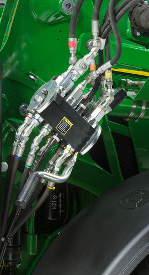 Single-point hydraulic connection on 5R
Single-point hydraulic connection on 5R
The 540R Loaders comes base equipped with single-point hydraulic connector. This feature saves time and effort when installing and removing the loader.
To disconnect the hydraulic connection between the loader and the tractor, it is necessary to relieve the hydraulic system oil pressure on the tractor.
Concealed oil lines improve appearance and reduce damage
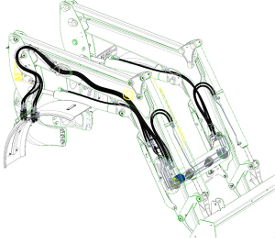 Concealed oil lines through boom arm (picture shown is from H-Series Loader)
Concealed oil lines through boom arm (picture shown is from H-Series Loader)
 Oil lines routed through the boom arm
Oil lines routed through the boom arm
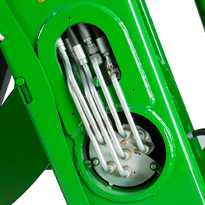 Oil lines routed through the torque tube
Oil lines routed through the torque tube
Through time, increased width in tractor hoods have caused issues with available space for running traditional oil lines of a loader along the boom, making them more susceptible to damage.
To improve this situation, the oil lines have been routed through the boom arm and the torque tube, improving line protection and the appearance of the loader.
Loader removal (parking) made easy
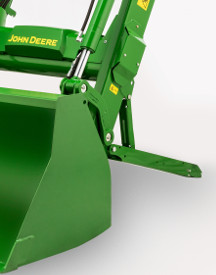 Parking stands
Parking stands
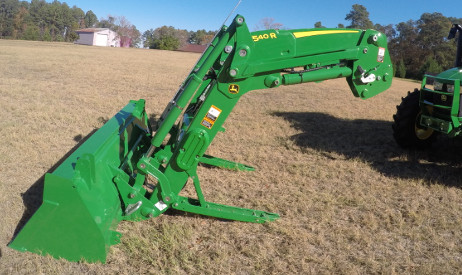 Parking stands
Parking stands
Only leave the operator station once to disconnect the loader
John Deere loaders are easily removed and reinstalled on tractors without tools. The automatic mast latch (AML) parking system allows removing or attaching the loader to the tractor in minutes without the need for tools.
Easy and quick steps to disconnect the loader:
- Lower the loader to ground, turn tractor off and release hydraulic pressure from joystick
- Exit operator station
- Open / lower parking stands (both left and right)
- Turn the boom cylinder valve lever to the unlocked position
- Remove loader hydraulics
- Unlock the mast pins (both left and right) and then able to back away
Removing or parking the loader
To disconnect the loader, the bucket has to be flat on a stable ground (1). The operator has to place the bucket flat on the ground, turn off tractor and release hydraulic pressure from joystick. (2) Exit the operator station and (3) lower the self-adjustable parking stands on both sides of the loader. The self-adjustable parking stands allow the driver to park the loader on irregular terrain and still keep a good position relative to the mounting frame, to attach the loader correctly later on. The parking stands can be set without tools. (4) After lowering the parking stands, the hydraulic couplers on the right-hand side of the loader have to be removed and (5) the loader must be unlocked from the tractor mounting frames (both right and left side).
After these easy steps, the operator is ready to move the tractor.
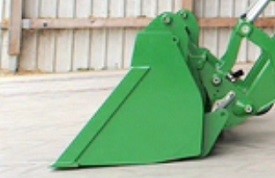 Loader placed on the ground with the bucket leveled (1)
Loader placed on the ground with the bucket leveled (1)
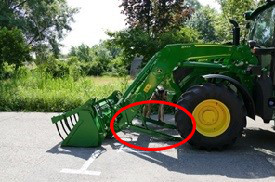 Open the parking stands (3)
Open the parking stands (3)
 Remove loader hydraulics (4)
Remove loader hydraulics (4)
 Loader hydraulics
Loader hydraulics
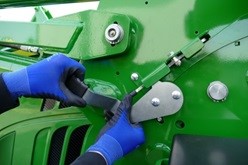 Unlock the loader mast (5)
Unlock the loader mast (5)
 From operator station, locking pins indicators
From operator station, locking pins indicators
Connecting the loader
Connecting the loader is fast and convenient thanks to the ramp design on the mounting frames and the AML equipped with a floating device. Only drive the tractor to bring the mounting frames inside the mast until the latching indicators are in lock position (visible from operator's station). Then the driver can lift up the parking stands, connect the hydraulic coupler for hydraulic and electric loader power to the tractor. Fast, intuitive and maintenance-free design, the loader connection and disconnection brings the tractor ready for any tasks.
 Mounting frame approach into AML
Mounting frame approach into AML
 Two latched indicators from the operator's station
Two latched indicators from the operator's station
Boom lockout for easy service
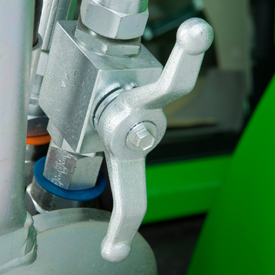 Hydraulic shut-off valve (open position)
Hydraulic shut-off valve (open position)
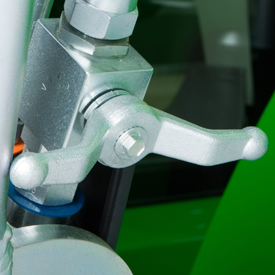 Hydraulic shut-off valve (closed position)
Hydraulic shut-off valve (closed position)
A hydraulic shut-off valve is included with the R-Series Loaders to ensure the loader does not lower suddenly. For example, this allows the boom to be locked out when someone is required to be located under the loader boom for service work on the tractor. It should not be used for extended periods of time unless an appropriate support stand is also utilized.
False rod bucket cylinders improve productivity
 False rod cylinder
False rod cylinder

Fast bucket cycle times are important to dump the load from the bucket as quickly as possible, (quite often) in order to be as productive as possible, while completing loading operations. The bucket cylinder design can have a major impact on this cycle time, especially for the mechanical self-leveling (MSL) loaders.
All MSL H-Series Loaders utilize false rod bucket cylinders. A false rod cylinder has a smaller displacement of oil requirement on the head end of the cylinder, which allows this cylinder to dump much faster than a normal cylinder.
Loader suspension system (LSS) to enhance the ride
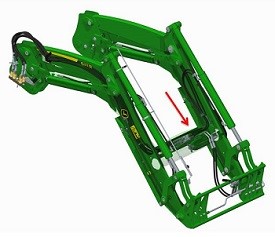 LSS
LSS
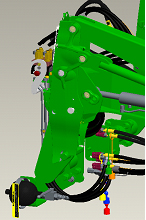 LSS on H180
LSS on H180
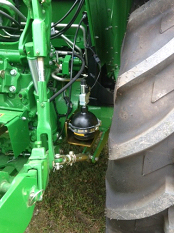 LSS on 5E and 5M
LSS on 5E and 5M
An enhancement to the loader is the suspension system. A great level of loader productivity is achieved with the LSS.
- An accumulator charged with nitrogen and connected to the head-end lift cylinder hose through a T-fitting provides shock absorption
- The cylinders move in and out to allow the boom to float
Performance
- Bales can be transported more efficiently from one end of the field to the other over frozen, hard-packed, or rutted terrain
NOTE: Check bale handling capability of tractor before use.
- Pallets can be moved easily without sustaining cargo damage
- Pallets of seed or fertilizer can be carried across a yard without a bag spilling and creating a costly mess
- Properly ballasted tractor with LSS has increased stability, creating a smoother ride for the operator
Cost of Ownership
-
Extended life of loader pins and bushings
-
Less stress on tractor axle
Reasons for turning LSS off include:
- Digging applications - with LSS on, the cylinders retract slightly, losing lifting power
- Holding a grade when blading - with LSS on, it is difficult to hold a constant grade
- Precise pallet and bale handling - with LSS on, the load moves up and down slightly while being positioned
- Parking a loader - with LSS on, when down pressure is applied, the lift cylinders retract slightly, making it more difficult to park
The switch is conveniently located in the operator station to avoid having to exit the operator station to manually move the handle on the LSS.
LSS can also be ordered with a manual shutoff. Depending on the tractor/loader model, the accumulator is located in different places. On the H180 the accumulator is mounted outside the bottom of the mounting frame. On the 5 Series Tractors, the accumulator is mounted near the inside of the rear right wheel. On 6 Series Tractors and larger, it is mounted in between the hydraulic connection and the mounting frame.
Features
Single-point hydraulic connection saves time
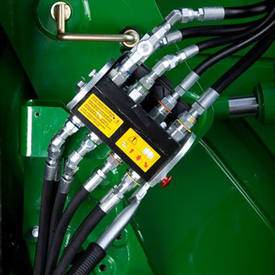 Single-point hydraulic connection on row-crop tractor (closed)
Single-point hydraulic connection on row-crop tractor (closed)
 Single-point hydraulic connection on utility tractor (closed)
Single-point hydraulic connection on utility tractor (closed)
The 520M, 540M, H240, H260, and H310 Loaders can be ordered with a single-point hydraulic connection that also incorporates the connection point for any electrical needs. To disconnect the hydraulic connection between the loader and the tractor, it is necessary to relieve the hydraulic system oil pressure on the tractor.
Concealed oil lines improve appearance and reduce damage
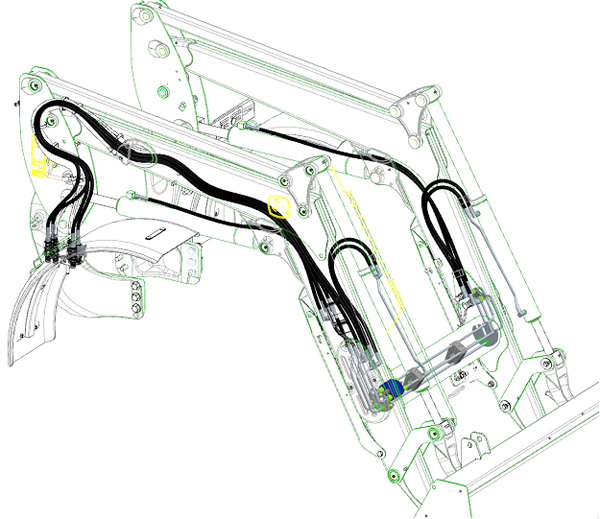 Concealed oil lines through boom arm
Concealed oil lines through boom arm

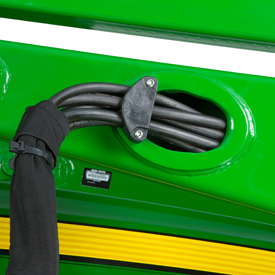 Oil lines routed through the boom arm
Oil lines routed through the boom arm
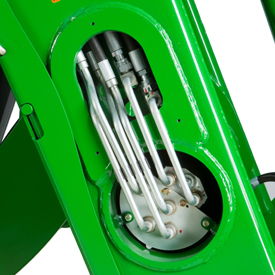 Oil lines routed through the torque tube
Oil lines routed through the torque tube
Over time, increased width in tractor hoods have caused issues with available space for running traditional oil lines of a loader along the boom, making them more susceptible to damage.
To improve this situation, the oil lines have been routed through the boom arm and the torque tube, improving line protection and the appearance of the loader.
Loader removal (parking) made easy
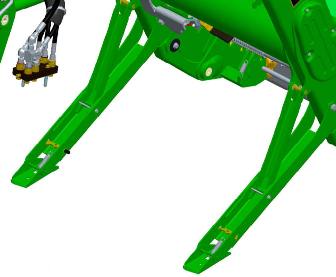 Parking stands
Parking stands

John Deere loaders are easily removed and reinstalled on tractors without tools. The parking system allows removing or attaching the loader to the tractor in minutes without the need for tools.
To remove or park the loader, apply slight down pressure to the loader boom with the bucket dumped at approximately a 30-degree angle. With the tractor in park, lower the parking stands and place the mast pins in the open position.
Removing or parking the loader
 Parking stand in stored position
Parking stand in stored position
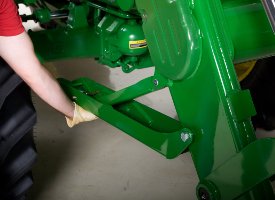 Removing parking stand
Removing parking stand
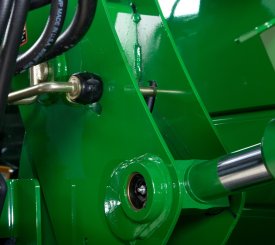 Mast pin in the closed position
Mast pin in the closed position
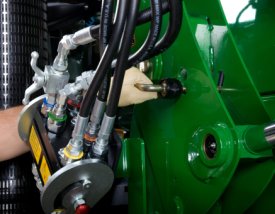 Rotating mast pin to the open position
Rotating mast pin to the open position
Utilizing the boom circuit with the tractor in neutral, rotate the mast forward until the mast has rotated past the pin location on the mounting frame by extending the lift cylinder. Now using the bucket circuit, roll back the bucket until the mast is removed from the pocket and will clear the tires.
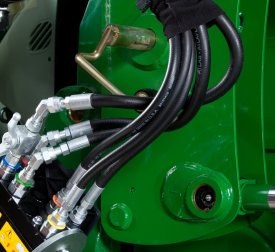 Mast pin in the open position
Mast pin in the open position
 Masts rotate forward, then bucket rolled back
Masts rotate forward, then bucket rolled back
With the tractor in park, shut the engine off and relieve the hydraulic pressure as indicated for the tractor (rotating the joystick). Disconnect or open the single-point hydraulic connector (or remove couplers if no single point is installed).
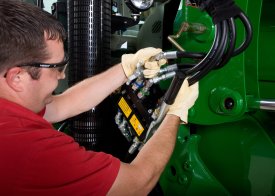 Disconnect/open single-point hydraulic connection
Disconnect/open single-point hydraulic connection
 Disconnect/open single-point hydraulic connections
Disconnect/open single-point hydraulic connections
Store the loader half of the single-point connector or hoses, and back away from the loader.
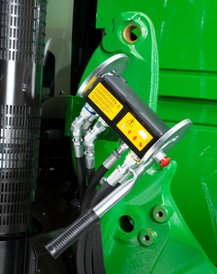 Single-point hydraulics disconnected
Single-point hydraulics disconnected

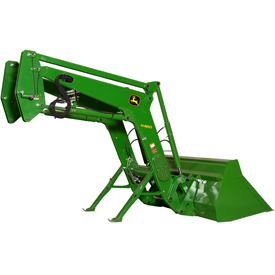 Parked loader
Parked loader
Boom lockout for easy service
 Hydraulic shut-off valve (open position)
Hydraulic shut-off valve (open position)
 Hydraulic shut-off valve (closed position)
Hydraulic shut-off valve (closed position)
A hydraulic shut-off valve is included with the H-Series Ag Loaders to ensure the loader does not lower suddenly. For example, this allows the boom to be locked out when someone is required to be located under the loader boom for service work on the tractor. It should not be used for extended periods of time unless an appropriate support stand is also utilized.
False rod bucket cylinders improve productivity
 False rod cylinder
False rod cylinder

Fast bucket cycle times are important to dump the load from the bucket as quickly as possible, in order to be as productive as possible, while completing loading operations. The bucket cylinder design can have a major impact on this cycle time, especially for the mechanical self-leveling (MSL) loaders.
Therefore, all MSL M- and H-Series Loaders utilize false rod bucket cylinders. A false rod cylinder has a smaller displacement of oil requirement on the head end of the cylinder, which allows this cylinder to dump much faster than a normal cylinder.
Loader suspension system (LSS) to enhance the ride
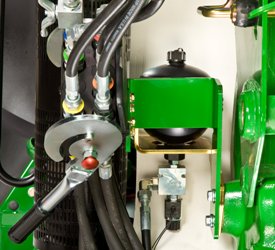 Nitrogen-charged accumulator and electric valve
Nitrogen-charged accumulator and electric valve
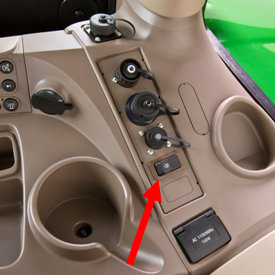 Operator on/off switch
Operator on/off switch
 LSS on H180
LSS on H180
 LSS on 5E and 5M
LSS on 5E and 5M
An enhancement to the loader is the suspension system. A great level of loader productivity is achieved with the LSS.
- An accumulator charged with nitrogen and connected to the head-end lift cylinder hose through a T-fitting provides shock absorption
- The cylinders move in and out to allow the boom to float
Performance
- Bales can be transported more efficiently from one end of the field to the other over frozen, hard-packed, or rutted terrain.
NOTE: Check bale-handling capability of tractor before use.
- Pallets can be moved easily without sustaining cargo damage
- Pallets of seed or fertilizer can be carried across a yard without a bag spilling and creating a costly mess
- A properly-ballasted tractor with LSS has increased stability, creating a smoother ride for the operator
Cost of ownership
-
Extended life of loader pins and bushings
-
Less stress on tractor axle
Reasons for turning LSS off include:
- Digging applications - with LSS on, the cylinders retract slightly, losing lifting power
- Holding a grade when blading - with LSS on, it is difficult to hold a constant grade
- Precise pallet and bale handling - with LSS on, the load moves up and down slightly while being positioned
- Parking a loader - with LSS on, when down pressure is applied, the lift cylinders retract slightly, making it more difficult to park
The switch is conveniently located in the operator station to avoid having to exit the tractor seat to manually move the handle on the LSS.
LSS can also be ordered with a manual shutoff. Depending on the tractor/loader model, the accumulator is located in different places. On the 440R, the accumulator is mounted outside the bottom of the mounting frame. On the 5 Series Tractors, the accumulator is mounted near the inside of the rear right wheel. On 6 Series tractors and larger, it is mounted in between the hydraulic connection and the mounting frame.
Features
Single-point hydraulic connection saves time
 Single-point hydraulic connection on row-crop tractor (closed)
Single-point hydraulic connection on row-crop tractor (closed)
 Single-point hydraulic connection on utility tractor (closed)
Single-point hydraulic connection on utility tractor (closed)
The 520M, H240, 540M, H260, and H310 Loaders can be configured with a single-point hydraulic connection that also incorporates the connection point for any electrical needs. To disconnect the hydraulic connection between the loader and the tractor, it is necessary to relieve the hydraulic system oil pressure on the tractor.
Loader removal (parking) made easy
 Parking stands
Parking stands

John Deere loaders are easily removed and reinstalled on tractors without tools. The parking system allows removing or attaching the loader to the tractor in minutes without the need for tools.
To remove or park the loader, apply slight down pressure to the loader boom with the bucket dumped at approximately a 30-degree angle. With the tractor in park, lower the parking stands and place the mast pins in the open position.
Removing or parking the loader
 Parking stand in stored position
Parking stand in stored position
 Removing parking stand
Removing parking stand
 Mast pin in the closed position
Mast pin in the closed position
 Rotating mast pin to the open position
Rotating mast pin to the open position
Utilizing the boom circuit with the tractor in neutral, rotate the mast forward until the mast has rotated past the pin location on the mounting frame by extending the lift cylinder. Using the bucket circuit, roll back the bucket until the mast is removed from the pocket and will clear the tires.
 Mast pin in the open position
Mast pin in the open position
 Masts rotate forward, then bucket rolled back
Masts rotate forward, then bucket rolled back
With the tractor in park, shut the engine off and relieve the hydraulic pressure as indicated for the tractor (rotating the joystick). Disconnect or open the single-point hydraulic connector (or remove couplers if no single point is installed).
 Disconnect/open single-point hydraulic connection
Disconnect/open single-point hydraulic connection
 Disconnect/open single-point hydraulic connections
Disconnect/open single-point hydraulic connections
Store the loader half of the single-point connector or hoses, and back away from the loader.
 Single-point hydraulics disconnected
Single-point hydraulics disconnected

 Parked loader
Parked loader
Boom lockout for easy service
 Hydraulic shut-off valve (open position)
Hydraulic shut-off valve (open position)
 Hydraulic shut-off valve (closed position)
Hydraulic shut-off valve (closed position)
A hydraulic shut-off valve is included with the M- and H-Series Ag Loaders to ensure the loader does not lower suddenly. For example, this allows the boom to be locked out when someone is required to be located under the loader boom for service work on the tractor. It should not be used for extended periods of time unless an appropriate support stand is also utilized.
False rod bucket cylinders improve productivity
 False rod cylinder
False rod cylinder

Fast bucket cycle times are important to dump the load from the bucket as quickly as possible, (quite often) in order to be as productive as possible, while completing loading operations. The bucket cylinder design can have a major impact on this cycle time, especially for the mechanical self-leveling (MSL) loaders.
Therefore, all MSL 520M and H-Series Loaders utilize false rod bucket cylinders. A false rod cylinder has a smaller displacement of oil requirement on the head end of the cylinder, which allows this cylinder to dump much faster than a normal cylinder.
Loader suspension system (LSS) to enhance the ride
 Nitrogen-charged accumulator and electric valve
Nitrogen-charged accumulator and electric valve
 Operator on/off switch
Operator on/off switch
 LSS on H180
LSS on H180
 LSS on 5E and 5M
LSS on 5E and 5M
An enhancement to the loader is the suspension system. A great level of loader productivity is achieved with the LSS.
- An accumulator charged with nitrogen and connected to the head-end lift cylinder hose through a T-fitting provides shock absorption
- The cylinders move in and out to allow the boom to float
Performance
- Bales can be transported more efficiently from one end of the field to the other over frozen, hard-packed, or rutted terrain.
NOTE: Check bale-handling capability of tractor before use.
- Pallets can be moved easily without sustaining cargo damage
- Pallets of seed or fertilizer can be carried across a yard without a bag spilling and creating a costly mess
- Properly ballasted tractor with LSS has increased stability, creating a smoother ride for the operator
Cost of ownership
-
Extended life of loader pins and bushings
-
Less stress on tractor axle
Reasons for turning LSS off include:
- Digging applications - with LSS on, the cylinders retract slightly, losing lifting power
- Holding a grade when blading - with LSS on, it is difficult to hold a constant grade
- Precise pallet and bale handling - with LSS on, the load moves up and down slightly while being positioned
- Parking a loader - with LSS on, when down pressure is applied, the lift cylinders retract slightly, making it more difficult to park
The switch is conveniently located in the operator station to avoid having to exit the operator station to manually move the handle on the LSS.
LSS can also be ordered with a manual shutoff. Depending on the tractor/loader model, the accumulator is located in different places. On the H180, the accumulator is mounted outside the bottom of the mounting frame. On the 5 Series Tractors, the accumulator is mounted near the inside of the rear right wheel. On 6 Series Tractors and larger, it is mounted in between the hydraulic connection and the mounting frame.
Features
Parking stands and couplers
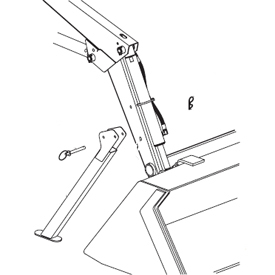 Parking stand
Parking stand
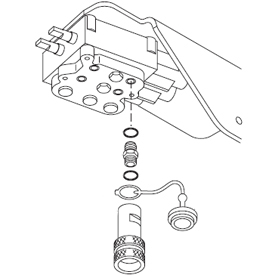 Parking stand coupler
Parking stand coupler
For parking the 512 Loader.
To see instructions on how to park the loader using the stands, go to parking stand section.
Changing attachments
The John Deere quick-change attachment carrier allows one person to quickly change attachments without the use of tools.
Step 1
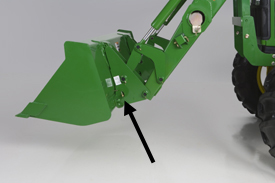 Retaining pin
Retaining pin
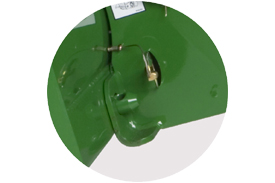 Detail of indicated area with pin in storage area
Detail of indicated area with pin in storage area
With the bucket level or slightly rolled back, simply remove the retaining pins and place in storage position.
Step 2
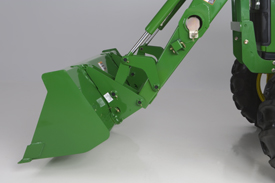 Roll the attachment forward to disengage pins
Roll the attachment forward to disengage pins
Roll the attachment forward to disengage the lower pins.
Step 3
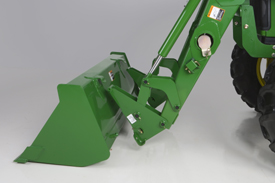 Lower attachment to ground-disengage top hooks
Lower attachment to ground-disengage top hooks
Lower the attachment to the ground to disengage the top hooks.
Step 4
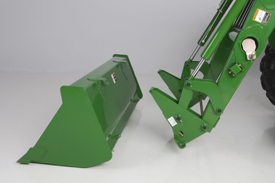 Back away from attachment
Back away from attachment
Back away.
To install another attachment simply reverse these steps.
Features
Single-point hydraulic connection saves time
 Single-point hydraulic connection on row-crop tractor (closed)
Single-point hydraulic connection on row-crop tractor (closed)
 Single-point hydraulic connection on utility tractor (closed)
Single-point hydraulic connection on utility tractor (closed)
The 520M, 540M, H240, H260, and H310 Loaders can be ordered with a single-point hydraulic connection that also incorporates the connection point for any electrical needs. To disconnect the hydraulic connection between the loader and the tractor, it is necessary to relieve the hydraulic system oil pressure on the tractor.
Concealed oil lines improve appearance and reduce damage
 Concealed oil lines through boom arm
Concealed oil lines through boom arm

 Oil lines routed through the boom arm
Oil lines routed through the boom arm
 Oil lines routed through the torque tube
Oil lines routed through the torque tube
Over time, increased width in tractor hoods have caused issues with available space for running traditional oil lines of a loader along the boom, making them more susceptible to damage.
To improve this situation, the oil lines have been routed through the boom arm and the torque tube, improving line protection and the appearance of the loader.
Loader removal (parking) made easy
 Parking stands
Parking stands

John Deere loaders are easily removed and reinstalled on tractors without tools. The parking system allows removing or attaching the loader to the tractor in minutes without the need for tools.
To remove or park the loader, apply slight down pressure to the loader boom with the bucket dumped at approximately a 30-degree angle. With the tractor in park, lower the parking stands and place the mast pins in the open position.
Removing or parking the loader
 Parking stand in stored position
Parking stand in stored position
 Removing parking stand
Removing parking stand
 Mast pin in the closed position
Mast pin in the closed position
 Rotating mast pin to the open position
Rotating mast pin to the open position
Utilizing the boom circuit with the tractor in neutral, rotate the mast forward until the mast has rotated past the pin location on the mounting frame by extending the lift cylinder. Now using the bucket circuit, roll back the bucket until the mast is removed from the pocket and will clear the tires.
 Mast pin in the open position
Mast pin in the open position
 Masts rotate forward, then bucket rolled back
Masts rotate forward, then bucket rolled back
With the tractor in park, shut the engine off and relieve the hydraulic pressure as indicated for the tractor (rotating the joystick). Disconnect or open the single-point hydraulic connector (or remove couplers if no single point is installed).
 Disconnect/open single-point hydraulic connection
Disconnect/open single-point hydraulic connection
 Disconnect/open single-point hydraulic connections
Disconnect/open single-point hydraulic connections
Store the loader half of the single-point connector or hoses, and back away from the loader.
 Single-point hydraulics disconnected
Single-point hydraulics disconnected

 Parked loader
Parked loader
Boom lockout for easy service
 Hydraulic shut-off valve (open position)
Hydraulic shut-off valve (open position)
 Hydraulic shut-off valve (closed position)
Hydraulic shut-off valve (closed position)
A hydraulic shut-off valve is included with the H-Series Ag Loaders to ensure the loader does not lower suddenly. For example, this allows the boom to be locked out when someone is required to be located under the loader boom for service work on the tractor. It should not be used for extended periods of time unless an appropriate support stand is also utilized.
False rod bucket cylinders improve productivity
 False rod cylinder
False rod cylinder

Fast bucket cycle times are important to dump the load from the bucket as quickly as possible, in order to be as productive as possible, while completing loading operations. The bucket cylinder design can have a major impact on this cycle time, especially for the mechanical self-leveling (MSL) loaders.
Therefore, all MSL M- and H-Series Loaders utilize false rod bucket cylinders. A false rod cylinder has a smaller displacement of oil requirement on the head end of the cylinder, which allows this cylinder to dump much faster than a normal cylinder.
Loader suspension system (LSS) to enhance the ride
 Nitrogen-charged accumulator and electric valve
Nitrogen-charged accumulator and electric valve
 Operator on/off switch
Operator on/off switch
 LSS on H180
LSS on H180
 LSS on 5E and 5M
LSS on 5E and 5M
An enhancement to the loader is the suspension system. A great level of loader productivity is achieved with the LSS.
- An accumulator charged with nitrogen and connected to the head-end lift cylinder hose through a T-fitting provides shock absorption
- The cylinders move in and out to allow the boom to float
Performance
- Bales can be transported more efficiently from one end of the field to the other over frozen, hard-packed, or rutted terrain.
NOTE: Check bale-handling capability of tractor before use.
- Pallets can be moved easily without sustaining cargo damage
- Pallets of seed or fertilizer can be carried across a yard without a bag spilling and creating a costly mess
- A properly-ballasted tractor with LSS has increased stability, creating a smoother ride for the operator
Cost of ownership
-
Extended life of loader pins and bushings
-
Less stress on tractor axle
Reasons for turning LSS off include:
- Digging applications - with LSS on, the cylinders retract slightly, losing lifting power
- Holding a grade when blading - with LSS on, it is difficult to hold a constant grade
- Precise pallet and bale handling - with LSS on, the load moves up and down slightly while being positioned
- Parking a loader - with LSS on, when down pressure is applied, the lift cylinders retract slightly, making it more difficult to park
The switch is conveniently located in the operator station to avoid having to exit the tractor seat to manually move the handle on the LSS.
LSS can also be ordered with a manual shutoff. Depending on the tractor/loader model, the accumulator is located in different places. On the 440R, the accumulator is mounted outside the bottom of the mounting frame. On the 5 Series Tractors, the accumulator is mounted near the inside of the rear right wheel. On 6 Series tractors and larger, it is mounted in between the hydraulic connection and the mounting frame.
Features
End-of-pin lubrication means easy maintenance
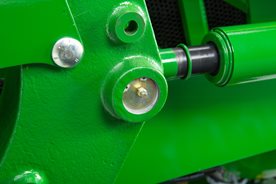 Close up of grease fitting
Close up of grease fitting
 Pivot point grease fitting locations (400X shown)
Pivot point grease fitting locations (400X shown)
All pivot points on the loader have grease fittings that are accessible from the side of the loader to make greasing the loader much easier, ensuring that all grease points are more likely to be serviced. No more searching for grease points that are hard to find. Removing the grease gun from the grease fitting is not a problem as sufficient radius has been left to allow the grease gun tip to be rotated to the side for removal from the fitting.
Parking stand kit
With the BW15872 parking stand kit, the 300E Loader can be quickly and easily removed from the tractor without tools.
Similarly, the BW16127 parking stand kit allows for the 400E Loader to be parked from the tractor.
Instructions for attaching the loader
Instructions for detaching the loader
The kit includes the following:
-
Parking stands
-
Handled pins
-
Hydraulic hoses
-
Quick-couplers
-
Mounting bracket and hardware
 Parking stand installed
Parking stand installed
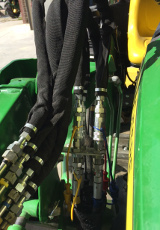 Quick disconnect connected
Quick disconnect connected
 Boom pins installed
Boom pins installed
Features
Quik-Park™ loader mounting system
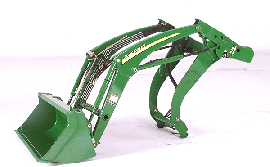 Quik-Park loader mounting system
Quik-Park loader mounting system
Quik-Park™ equipped loaders are designed for easy removal and mounting to and from the tractor without tools.
The parking stand, attached to the front frame of the tractor, is an integral part of the loader during loader operation.
The parking stand lowers into position by moving the joystick to the raised position once the latches are opened. This allows the loader to move to the parked position.
Quik-change attachment carrier
 Quik-change attachment carrier
Quik-change attachment carrier
Allows fast, easy removal/mounting of attachments without tools.
End-of-pin lubrication means easy maintenance
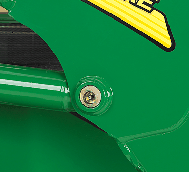 Close up of grease fitting
Close up of grease fitting
 Pivot point grease fitting locations
Pivot point grease fitting locations
All pivot points on the loader have grease fittings that are accessible from the side of the loader to make greasing the loader much easier, ensuring that all grease points are more likely to be serviced. No more searching for grease points that are hard to find. Removing the grease gun from the grease fitting or zerk is not a problem either as sufficient radius has been left to allow the grease gun tip to be rotated to the side for removal from the fitting or zerk.
Features
Quik-Park™ loader mounting system
 Quik-Park loader mounting system
Quik-Park loader mounting system
Quik-Park™ equipped loaders are designed for easy removal and mounting to and from the tractor without tools.
The parking stand, attached to the front frame of the tractor, is an integral part of the loader during loader operation.
The parking stand lowers into position by moving the joystick to the raised position once the latches are opened. This allows the loader to move to the parked position.
End-of-pin lubrication means easy maintenance
 Close up of grease fitting
Close up of grease fitting
 Pivot point grease fitting locations
Pivot point grease fitting locations
All pivot points on the loader have grease fittings that are accessible from the side of the loader to make greasing the loader much easier, ensuring that all grease points are more likely to be serviced. There is no more searching for grease points that are hard to find. Removing the grease gun from the grease fitting or zerk is not a problem either as sufficient radius has been left to allow the grease gun tip to be rotated to the side for removal from the fitting or zerk.
Features
End-of-pin lubrication - Easy maintenance
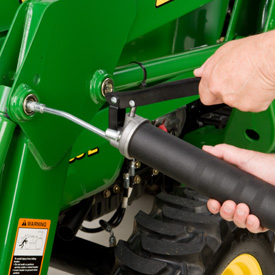 End-of-pin lubrication
End-of-pin lubrication
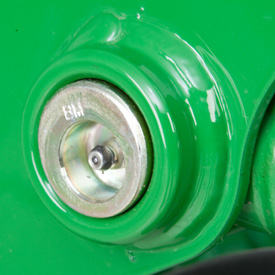 Closeup of grease fitting
Closeup of grease fitting
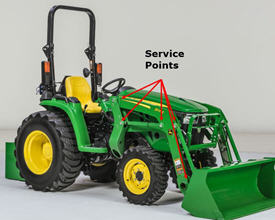 Grease points
Grease points
All pivot points on the loader have grease fittings that are accessible from the side of the loader to make greasing the loader much easier, ensuring that all grease points are more likely to be serviced. No more searching for grease points that are hard to find. Removing the grease gun from the grease fitting is not a problem as sufficient radius has been left to allow the grease gun tip to be rotated to the side for removal from the fitting.
Quik-Change attachment carrier
 Quik-Change attachment carrier
Quik-Change attachment carrier
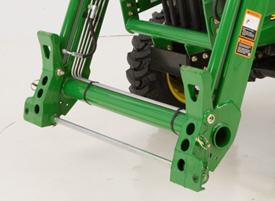 Quik-change attachment mounting
Quik-change attachment mounting
The quik-change attachment carrier allows for fast, easy removal and mounting of attachments without tools.
Parking stand kit
With the BW15872 parking stand kit, the 300E Loader can be quickly and easily removed from the tractor without tools.
Similarly, the BW16127 parking stand kit allows for the 400E Loader to be parked from the tractor.
Instructions for attaching the loader
Instructions for detaching the loader
The kit includes the following:
-
Parking stands
-
Handled pins
-
Hydraulic hoses
-
Quick-couplers
-
Mounting bracket and hardware
 Parking stand installed
Parking stand installed
 Quick disconnect connected
Quick disconnect connected
 Boom pins installed
Boom pins installed
Features
End-of-pin lubrication on cylinder and pivot pins allows easy access for servicing grease points
 Pivot pin
Pivot pin
The unique offset head design eliminates cross-pins and cotter pins to retain the pin.
A nut ensures the pins remain in position.
A lubrication groove provides a path for lubrication.
End-of-pin lubrication allows easy access for servicing grease points, which are visible from the side of the loader.
Quik-Park™ loader mounting system
 Quik-Park loader mounting system
Quik-Park loader mounting system
 Quik-Park loader mounting system
Quik-Park loader mounting system
The 220R Loader is designed for easy removal/mounting to/from the tractor without tools.
The parking stand is attached to the mast and lowers into position by moving the joystick to the raise position once the latches are opened to allow the loader to move to the park position.
To view a video of how the Quik-Park system works, click here.
NOTE: This video only shows the dismount and mount of the loader without disconnecting the hydraulics. To completely remove the loader, the operator must turn the tractor off, relieve the hydraulics, and then disconnect the hoses from the couplers.
Features
Easily remove and mount loader to and from the tractor without tools
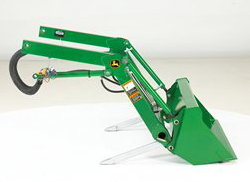 Parking mounting system
Parking mounting system

The parking mounting system on the D120 Loader is designed for easy removal and mounting to and from the tractor without tools.
Similar to that of the 305 Loaders, the D120’s parking stands are kept in the torque tube for easy accessibility. To park the loader, simply install parking stands, remove pivot pins from the mast, disconnect the hydraulic hoses, and back out the tractor.
 Easy removal and mounting
Easy removal and mounting
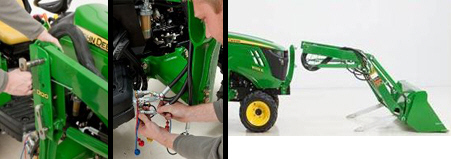 Mount to and from tractor without tools
Mount to and from tractor without tools
End-of-pin lubrication on cylinder and pivot pins allows easy access for servicing grease points
 Pivot pin
Pivot pin
The unique offset head design eliminates cross-pins and cotter pins to retain the pin.
A nut ensures the pins remain in position.
A lubrication groove provides a path for lubrication.
End-of-pin lubrication allows easy access for servicing grease points, which are visible from the side of the loader.
Features
CommandCenter™ display
Overview
The Generation 4 CommandCenter creates the primary user interface for 6R Series Tractors. The Generation 4 CommandCenter provides an excellent, user-savvy operating experience.
Producers can also use a variety of implements with the Generation 4 CommandCenter as it is ISOBUS virtual terminal (VT) capable.
Expect machine productivity gains, along with increased operator confidence, thanks to a simple, customizable interface. The reliability of the Generation 4 CommandCenter also aids in optimal operating experience and maximizes uptime.
 4200 CommandCenter 21.3-cm (8.4-in.) display
4200 CommandCenter 21.3-cm (8.4-in.) display
 4600 CommandCenter 25.4-cm (10-in.) display
4600 CommandCenter 25.4-cm (10-in.) display
Benefits
- Easy-to-change fields and guidance lines
- Custom-defined views
- On-screen help functions
- Intelligent warnings
- Context-based help
Details
| Code | Description |
| 1947 | 4200 Processor (21.3-cm [8.4-in.] display only) |
| 1946 | 4600 Processor (25.4-cm [10-in.] display only) |
| Code | Description |
| 1829 | 21.3-cm (8.4-in.) CommandCenter display (4200 Processor only) |
| 1822 | 25.4-cm (10-in.) CommandCenter display (4600 Processor only) |
| Code | Description |
| 1867 | Less application |
| 1851 | CommandCenter AutoTrac™ activation |
| 1858 | 4200 Section Control and Data Sync activation plus CommandCenter AutoTrac activation |
| 1857 | 4600 CommandCenter Premium Activation 3.0 |
| 1861 | 4600 CommandCenter Automation Activation 1.0 |
| 186S | 4600 CommandCenter Automation Activation 3.0 |
NOTE: CommandCenter AutoTrac activation stays with the tractor.
NOTE: 6155RH only available with code 1867.
 Help center main page
Help center main page
Additionally, application-based help is also available in all locations of the CommandCenter. Simply click on the (i) icon available on the title bar and it will lead directly to more information on the application currently being used.
Display options
Generation 4 CommandCenter displays are available in the following configurations:
- 21.3-cm (8.4-in.) display on the 4200 CommandCenter
- 25.4-cm (10-in.) display on the 4600 CommandCenter
For those wanting to maximize their viewing real estate, the 25.4-cm (10-in.) touchscreen color display is an excellent choice. With the 25.4-cm (10-in.) display, the title bar and all shortcut keys may be viewed at all times. Operators can monitor more items at once on the 25.4-cm (10-in.) touchscreen display.
Layout Manager
 Layout Manager selection page
Layout Manager selection page
 Layout Manager module build
Layout Manager module build
The Generation 4 CommandCenter features a modular-designed layout manager so an operator can easily create the structure that meets the operator’s demands. From the factory, machines are equipped with standard run pages. An unlimited amount of run pages can be added to the Generation 4 CommandCenter based on operator preference or operational needs. Toggling between run pages is as easy as swiping the screen or using the arrow buttons on the top right portion of the title bar.
Users and access
Users and access allow the owner to lock out certain functions to prevent operators from accessing or changing settings. Lock-out functions are managed with an owner-defined four-digit code.
Lockout features are available for:
- Precision Ag Technology applications
- Hitch
- Hydraulic
- Transmission
- Power take-off (PTO)
- FieldCruise™ engine controls
- Display
- Machine monitor
On-screen help and diagnostic text
There are a number of different ways to get meaningful on-screen help when navigating the Generation 4 CommandCenter. Operators can find the help icon on the shortcut bar on the bottom of every page. This icon gives detailed information on everything from tractor operation to application information. Simply select the help icon and navigate to the information section that is needed.
Work monitor
 Work monitor page
Work monitor page
The work monitor application displays the performance information about the task being performed by the machine. The user is shown averages, totals, and productivity of the machine, such as area worked, average working speed, and fuel usage. The values of the work monitor can be reset by the user at any time. Specific values of the work monitor can be configured by the user to be shown on a run page.
NOTE: The work monitor application replaces part of the universal performance monitor in previous machines.
Video capability
Tractors with a 4200 CommandCenter are equipped with one video input and tractors with a 4600 CommandCenter have two video inputs. The operator has the ability to set a variety of triggers, including reverse, PTO, hitch, and selective control valve (SCV) levers to activate the camera. The image will then appear on the CommandCenter display. The camera (video observation system) is available through JD Parts and Ag and Industrial (A & I) Products.
John Deere Generation 4 CommandCenter processors
A Generation 4 CommandCenter is made up of a processor and a display. Two processor options are available for the Generation 4 CommandCenter.
The 4600 Processor is the premium processor. Available features with the premium processor include:
- Compatible with 25.4-cm (10-in.) touchscreen display
- Two video camera inputs
- One USB input
- AutoTrac capable (machine-specific activation sold separately)
 Context-based help iTEC™ main page
Context-based help iTEC™ main page
Diagnostic text and information is available for better understanding of whether applications are operating as directed.
Machine monitor
 Machine monitor page
Machine monitor page
The machine monitor application provides the user instantaneous readings about the status or condition of the machine. Values shown in the machine monitor vary by application, but typically include parameters like engine speed, coolant temperature, and ground speed. The machine monitor supports run page modules in the layout manager, allowing the user to populate specific machine parameters directly to a run page.
NOTE: The machine monitor application replaces part of the Universal Performance Monitor in previous machines.
 25.4-cm (10-in.) 4600 CommandCenter display
25.4-cm (10-in.) 4600 CommandCenter display
The 4200 Processor is base equipment on all 6R Tractors. It offers:
- Compatible with 21.3-cm (8.4-in.) touchscreen display
- One video camera input
- One USB input
- AutoTrac capable (machine-specific activation sold separately)
| Tractors | 4600 Processor | 4200 Processor |
| 6R | Option | Standard |
 John Deere 4200 CommandCenter
John Deere 4200 CommandCenter
A. Next run page
B. Status center
C. Expand shortcut keys
D. Menu
E. Run page
 John Deere 4600 CommandCenter
John Deere 4600 CommandCenter
A. Next and previous run page
B. Status center
C. Shortcut keys
D. Menu
E. Run page
F. Title bar
Infinitely Variable Transmission (AutoPowr™/IVT™) system
Overview
The John Deere Infinitely Variable Transmission (AutoPowr/IVT) utilizes a combination of mechanical and hydrostatic power, providing stepless and continuous power across an infinitely variable range of speeds.
Single-speed lever is used for intuitive and accurate control of ground speeds as slow as 50 m/h (0.03 mph) to 40/50 km/h (25/31 mph). In model year 2015, the transmission was revised so transport speeds are reached at lower engine rpms, ultimately reducing fuel consumption and in cab noise. Software has also been revised to ensure under acceleration engine rpm is kept to a minimum within the engines peak torque band.
 AutoPowr/IVT transmission
AutoPowr/IVT transmission
Benefits
- Easy to operate
- Four mechanical modes lead to excellent performance and reduced fuel consumption
- Revised ratios bring transport speeds at reduced engine rpm – reduced fuel consumption and increased comfort
- Precise management of forward speeds
- Less shifting time means better management of the implement
Details
- Requires 240-amp alternator (code 8743) (6110R, 6120R, and 6130R)
- Requires code electrohydraulic (EH) selective control valves (SCVs) and 240-amp alternator
- Requires braked front axle (code 6070)
- Requires hydraulic trailer brakes (code 8756)
- Requires B-speed rated tires and front fenders (8011 or 8012)
NOTE: Not available in 6155RH.
| Code | Description |
| 1552 | AutoPowr/IVT – 50 km/h (31 mph) |
Details
- Requires code EH SCVs
- Requires 240-amp alternator (code 8743) (6110R, 6120R, and 6130R)
NOTE: Not available in 6155RH.
| Code | Description |
| 1551 | AutoPowr/IVT – 40 km/h (25 mph) |
50 km/h (31 mph)
 6R in transport
6R in transport
The following features are part of the 50 km/h (31 mph) package:
- Triple-Link Suspension (TLS™) Plus system with brakes for improved braking capacity
- Rim and tire matching with fixed tread rims to minimize vibration and increase ride comfort
- Trailer brakes
- Front and rear fenders
Set-speed adjusting wheel
Overview
The set-speed adjusting wheel is the rotational thumbwheel located on the speed control lever. The wheel is quick and easy to adjust with the operator’s thumb and rotates infinitely with no stop or start position. When the operator rotates the thumbwheel, the ground speed of the tractor is increased by 0.2 km/h (0.12 mph) when the tractor is traveling below 20 km/h (12 mph). When the tractor is traveling above 20 km/h (12 mph), the tractor is increased by (1) km/h (0.6 mph). The set speed adjuster is used to set the maximum commanded forward or reverse speed in each speed band.
As the operator moves the lever within or between speed bands, the electronic management system ensures smooth, quick, and powerful acceleration or deceleration, regardless of load or ground speed.
While in motion, the operator can adjust the maximum speed of each speed band. With the lever in band one, the target maximum speed can be adjusted to 20 km/h (12 mph). With the lever in band two, the maximum speed of 40/50 km/h (25/31 mph) can be defined depending on transmission option. When stationary, all set speeds, both forward and reverse, may be adjusted while the left-hand reverser is in the power zero position.
 Thumbwheel located on the speed control lever
Thumbwheel located on the speed control lever
 Lever slot between speed brands
Lever slot between speed brands
 Left-hand reverser
Left-hand reverser
For tractors with CommandPRO, the left-hand reverser incorporates only forward and reverse direction selection and the lever is self-centering. The park (P) and neutral (N) positions can be selected on the CommandPRO.
 Full auto screenshot on CommandCenter display
Full auto screenshot on CommandCenter display
Custom mode
Overview
Custom mode allows the operator to customize the AutoPowr/IVT transmission settings when full auto mode is not desirable. In custom mode, operators can turn ECO on and off. This can either be done by pushing the ECO button on the side of the hand throttle module or by selecting ECO in the transmission settings page of the CommandCenter display. When accelerating with ECO on, the tractor minimizes engine speeds, which reduce acceleration aggressiveness. As a result, ECO on should reduce fuel consumption in lighter, steady loads. In contrast, when accelerating with ECO off, engine speed can be higher aggressively to maximize productivity. The higher engine speeds with ECO off better enable the tractor to quickly recover from sudden load increases and not lose as much ground speed when load increases occur.
In custom mode, the engine droop settings can be defined between 4 percent and 30 percent with PTO on and off. The higher the droop percentage, the more the engine rpm will be reduced when pulling before a transmission ratio change is made.
 Drop-down information for set speeds on CommandCenter™ display when rotating the thumbwheel
Drop-down information for set speeds on CommandCenter™ display when rotating the thumbwheel
 Set speed indicated in the dashboard
Set speed indicated in the dashboard
Benefits
- Quick and precise speed changes
- Fine-tuning via the speed wheel
- Two steps in the slot of the speed control lever to program two set speeds
- Speed feedback on the analog dashboard – the needle shows the actual speed, and red lights around the needle show the commanded speed
- Easy-to-handle exact-speed settings through the CommandCenter display and the speed wheel
Left-hand reverser
Overview
An easy-to-use left-hand reverser is available in all the AutoPowr/IVT transmissions. The reverser control is located at the 10 o’clock position on the steering column for intuitive control. For tractors without the CommandPRO™ joystick, the left-hand reverser incorporates the following controls:
- Forward direction selector
- Reverse direction selector
- Park (P) - Park lock (P) - Tractor cannot move and the trailer brakes are engaged. Lever must be in the (P) park position to start the tractor.
- Neutral (N) – Tractor is in a non-parked position and capable of movement.
- Power zero – Tractor is held stationary by the transmission.
 Left-hand reverser if equipped with CommandPRO
Left-hand reverser if equipped with CommandPRO
Benefits
- Tractors without CommandPRO allow for temporary stationary control of the tractor without using the brakes. For tractors with CommandPRO, ActiveZero is always in place when the tractor is not in N or P and brakes are not applied.
- Quick and easy way for the operator to change the direction of the tractor.
- Ensures that the tractor cannot be operated with the park lock on.
Electronic hand and foot throttle
Overview
The tractor ground speed is controlled via the accelerator and hand throttle. The engine rpm can be set to a specific ground speed using the hand throttle (A). The following functions are available for tractors without CommandPRO:
- Button (B) activates and de-activities the FieldCruise™ system (with two available pre-sets), which is an engine rpm limiter.
- The specific ground speed set can be set by pressing button (C); this pedal lock feature works like the cruise control on a car (only functions when foot throttle is ordered).
- Button (D) allows the operator to drive with the minimum target rpm with ECO on.
- NOTE: Button (D) is only active in custom mode.
 Hand throttle
Hand throttle
The following functions are available for tractors with CommandPRO:
- Button (B) and (D) activate and de-activate engine set speeds that can be set in the CommandCenter display.
- Button (C) can be used to fix the engine speed command to the current hand throttle position (no automatic engine speed control).
 Hand throttle when equipped with CommandPRO
Hand throttle when equipped with CommandPRO
 Foot throttle
Foot throttle
Benefits
- Define setting of the engine speed and its limit with the FieldCruise system
- Quick attainment of desired speed
- Pedal lock function allows command foot throttle speed to be maintained
AutoPowr/IVT selector control via CommandCenter display
Overview
The AutoPowr/IVT application setting employs four modes to take full advantage of the engine-transmission communication: full AUTO, custom, pedal and manual.
Full AUTO mode
Overview
Full AUTO mode enables the tractor to make adjustments to the transmission operating mode automatically, based on the engine and transmission speeds and the load on the tractor. This should be the AutoPowr/IVT transmission setting for 95 percent of all applications.
Full AUTO mode switches between load control and fuel economy mode seamlessly, with no involvement from the operator, as conditions and applications change. Fuel economy mode automatically switches off when the power take-off (PTO) is engaged to provide full PTO power. Operators can set the maximum forward and reverse speeds for the tractor in their particular application.
NOTE: Activation ECO is not available in full auto mode.
 Pedal mode display on CommandCenter display
Pedal mode display on CommandCenter display
Benefits
- Pedal mode is ideal for applications like mowing, baling, or hedge cutting, where it is important to keep the engine speed at a constant rpm independent from the ground speed.
Manual mode settings
Overview
Manual mode makes the transmission and engine independent of each other. The transmission does not automatically adjust engine rpm to save fuel. This can prove to be useful in applications like loader work, where the variability of engine speed based on load is not needed.
 Load anticipation display on CommandCenter display
Load anticipation display on CommandCenter display
Benefits
- John Deere exclusive feature
- Tractor recognizes when additional engine rpm is needed
- Saves fuel, because the engine shuts down when no additional power is needed
Forward/Reverse relationship
Overview
Similar to the AutoQuad™ PLUS transmission, the AutoPowr/IVT transmission can also adjust the forward/reverse speed ratio. The reverse speeds can be set to a maximum of 30 percent higher and 70 percent lower than forward speeds, but only in range 1. In range 2, the forward-to-reverse speed ratio is 1:1, up to 22 km/h (14 mph). Above that, the reverse speeds will only go up to 30 km/h (19 mph).
 Section of forward/reverse relationship via CommandCenter display
Section of forward/reverse relationship via CommandCenter display
Brake with integrated AutoClutch function
Overview
With the AutoPowr/IVT transmission, no clutching is required to stop the tractor. After the brakes are released, the tractor automatically accelerates back to its previous speed (if using hand throttle). The effect of AutoClutch can also be set via the CommandCenter display.
 Operator presses brake pedal to stop the tractor
Operator presses brake pedal to stop the tractor
 AutoClutch sensitivity change on CommandCenter display
AutoClutch sensitivity change on CommandCenter display
Benefits
- This feature makes the AutoPowr/IVT an ideal transmission for operations that require a lot of speeds (like baling or loader work).
- Upon release of the AutoClutch, the tractor will accelerate to the previous command speed (ideal for round baling).
- Excellent modulation makes inching to implements and attachments easy.
Torque
Overview
The AutoPowr/IVT transmission is a combination of mechanical and hydraulic components that are capable of providing low speed with extremely high levels of torque:
- Allows the tractor to smoothly pull away, even under high loads
- Enhances front loader operation by delivering high torque, driving the tractor into the pile without slippage
- Retains constant working speeds with PTO implements, which have a tendency to push the tractor (spading or rotary cultivator)
Creeper mode
Creeper mode is a standard feature on the AutoPowr/IVT transmission. Down to 50 m/h (164 ft/h), the creeper mode is activated when the selected speed is below 2.1 km/h (1.3 mph) in set position 1.
When the tractor moves below 600 m/h (1968 ft/h), the engine speed is independent of travel speed. This allows the operator to choose the engine speed that best fits the task (rated speed for hydraulic or PTO usage, or low idle for fuel-saving operation). No additional power is needed.
 Customizing speed of direction on CommandCenter display
Customizing speed of direction on CommandCenter display
 Droop setting on CommandCenter screen
Droop setting on CommandCenter screen
Benefits
- Ensure that the operator has the best driving options when required
- Independent droop settings allow the operator improved performance and flexibility
Pedal mode settings
Overview
Pedal mode allows the operator to change the tractor’s ground speed independently from the engine speed. The ground speed is controlled through use of the foot pedal while the hand throttle determines engine speed. Maximum ground speed is determined by the location of the speed control lever in the speed band. Operators can lock-in a desired ground speed without pressure on the foot pedal using the pedal lock button (as described above). To unlock the foot pedal, the operator can tap the foot pedal, press the lock button, or press the brake pedal. When releasing the foot pedal, the vehicle decelerates to a safe creep speed. To come to a complete stop, the brake pedal should be depressed.
 Manual mode display on CommandCenter display
Manual mode display on CommandCenter display
Load anticipation feature
Overview
The load anticipation feature allows the AutoPowr/IVT transmission to predict how much load the engine expects from the activation of the hitch or a particular SCV function.
In full AUTO mode, all load anticipation features are active. In custom mode, they can be turned on or off in the custom settings page. When an SCV or the hitch is activated, the engine speed is raised to 1500 rpm (as long as the commanded throttle position is over this value). This creates a boost in engine power which improves hydraulic performance and prepares the engine for potential load situations (for example, returning an implement to work). Also added is PTO load anticipation. If it is turned off, the engine does not react to PTO engagement and engine speed is controlled purely based on load. If turned on (in custom), when the PTO is engaged, the engine rpm will rise to throttle position or pre-defined PTO cruise setting.
Rear-mounted selective control valves (SCVs)
Overview
To control a rear implement, up to six SCVs or five SCVs plus Power Beyond can be ordered (6145R-6250R). For (6110R- 6130R) up to five SCVs or four SCVs plus Power Beyond can be ordered. The SCVs can be controlled electrically. Up to four mechanical SCVs are available, in combination with Power Beyond. All mechanical or electrical SCVs feature four positions - neutral, raise, lower, and float.
Benefits
- Release levers make disconnecting hydraulic hoses easy
- Relocated valves improve operator's visibility to the rear hitch
- Up to six rear SCVs give operators total flexibility
| Code | Description | Information | Availability |
| 3312 | Two mechanical SCVs – premium | Premium couplers with high-pressure relief lever. Two mechanical SCVs 450 Series. Only in combination with PowrQuad™ Plus transmission or AutoQuad™ Plus transmission. Only available on 6110R - 6130R. |
6110R, 6120R, 6130R |
| 3332 | Three mechanical SCVs - premium | Premium couplers with high-pressure relief lever. Only in combination with PowrQuad Plus or AutoQuad Plus. | 6110R, 6120R, 6130R, 6145R, 6155R, 6175R, 6195R, 6215R |
| 3311 | Two electronic SCVs - premium | Premium couplers with high-pressure relief lever. | 6110R, 6120R, 6130R |
| 3331 | Three electronic SCVs - premium | Premium couplers with high-pressure relief lever. | 6110R, 6120R, 6130R, 6145R, 6155R, 6175R, 6195R, 6215R, 6230R, 6250R |
| 3341 | Four electronic SCVs - premium | Premium couplers with high-pressure relief lever. | 6110R, 6120R, 6130R, 6145R, 6155R, 6175R, 6195R, 6215R, 6230R, 6250R NOTE: Not available for 6155RH. |
| 3351 | Five electronic SCVs – premium | Premium couplers with high-pressure relief lever. When ordered with right-hand console, (code 2055) also electrical joystick (code 841L) for operation of rear SCVs or electrical midstack SCV (code 8922, 8923, 8914 or 8915) is required. A maximum of four SCVs can be operated via paddle pot at right-hand console. | 6110R, 6120R, 6130R, 6145R, 6155R, 6175R, 6195R, 6215R, 6230R, 6250R NOTE: Not available for 6155RH. |
| 3361 | Six electronic SCVs – premium | Premium couplers with high-pressure relief lever. Not with right-hand console (code 2055). Not in combination with electrical joystick (code 841L) and any option with electrical joystick. | 6145R, 6155R, 6175R, 6195R, 6215R, 6230R, 6250R NOTE: Not available for 6155RH. |
Mechanical control valves
Overview
The tractor may be equipped with one type of mechanical control valves: premium (450 Series).
Premium-couplers control valves also have an additional lock function (position 3), which holds the control lever in the raise or lower position until the pressure in the oil circuit has reached a predetermined value (e.g., when the control cylinder has reached its end position).
In position 2, the control lever returns to neutral as soon as it is released and is the setting for normal hydraulic operation.
If an implement is connected, pressure connection has to be connected to the lower coupler. With standard SCVs, a valve prevents sudden loss of pressure caused by leakage when the engine is shut off.
On premium SCVs, the likelihood of leakage is further diminished.
 Premium mechanical control valve (premium)
Premium mechanical control valve (premium)
- Position 1
- Position 2
- Position 3
- Hydraulic oil flow control
Electrical control valves
Overview
The tractor may be equipped with the premium (450 Series) control valves. All main characteristics can be controlled by the CommandCenter™ display.
 CommandCenter hydraulics option
CommandCenter hydraulics option
Example options of rear valve configuration
 3351 – five electronic SCVs (five SCV premium)
3351 – five electronic SCVs (five SCV premium)
 3361 – six electronic SCVs (six SCV premium)
3361 – six electronic SCVs (six SCV premium)
Hydraulic control options
 E-SCV controls on the right-hand console
E-SCV controls on the right-hand console
 M-SCV controls on the right-hand console
M-SCV controls on the right-hand console
 E- SCV controls on CommandARM™ controls
E- SCV controls on CommandARM™ controls
 E-SCV controls on optional joystick (reconfigurable)
E-SCV controls on optional joystick (reconfigurable)
Hydraulic set up
Shortcut button right-hand console
Overview
Simply push the hydraulic symbol on the right-hand side console or the CommandCenter and the CommandCenter display shows a setup menu to:
- Monitor valve status - detent, float, or neutral
- Adjust maximum flow and detent (combine for both direction or separate extent and retract adjustment)
 Hydraulic shortcut button on right-hand console
Hydraulic shortcut button on right-hand console
 Hydraulic shortcut button CommandCenter
Hydraulic shortcut button CommandCenter
Detent setup
Overview
- Time detent - this is particularly useful when repeat SCV operations are performed, such as lowering a mower-conditioner plow or cycling planter markers.
- Continuous flow detent - this is particularly useful when a hydraulic motor is used, such as on an air seeder.
 Detent setup
Detent setup
SCV flow setup
Overview
SCV flow rate can be programmed between 0.04 and 10 allowing fine tuning for implements with different hydraulic requirement.
Behavior can be set between linear (red), progressive (green), or a combination (yellow) for exact flow modulation and precise valve management.
- Linear means that the distance travelled by the SCV/ICV corresponds to the distance travelled by the control lever/multifunction lever
- Progressive means that initially the distance travelled by the SCV/ICV is less than that travelled by the control lever/multifunction lever (giving a more sensitive start to the movement)
 Flow setup
Flow setup
 Three flow options
Three flow options
 Flow characteristic setup
Flow characteristic setup
Combination is an intermediate stage between the two settings listed above.
CommandPRO™ joystick driving strategy
The optional CommandPRO joystick combines a unique driving strategy with reconfigurable controls.
 CommandARM™ controls with CommandPRO
CommandARM™ controls with CommandPRO
Layout and functions
 |
1 – travel set speed buttons 1 and 2 |
 |
4 – reconfigurable buttons and rocker switches (buttons 10 and 11, rocker switches C and D) |
Benefits
- 11 reconfigurable controls for both tractor and implement functions
- Possibility to operate tractor and ISOBUS functions at the same time on the CommandPRO joystick
- Intuitive and easy driving concept
| Code | Description |
| 2089 | Standard Cab with CommandPRO |
| 2091 | Premium Cab with CommandPRO |
| 2092 | Premium Cab with CommandPRO and cab suspension |
Default assignments

| Rocker D: selective control valve (SCV) II (if equipped) | Button 10: engine set speed 1 |
| Rocker C: SCV I (if equipped) | Button 11: engine set speed 2 |
| Rocker B: front hitch (if equipped) | Button 12: AutoTrac™ resume (if equipped) |
| Rocker A: rear hitch (if equipped) |
NOTE: For information about reconfigurability, please see operator's station functional area.
Driving strategy
The unique driving strategy is designed to deliver highest performance in combination with operator comfort making the daily work much easier and efficient.
- Pedal and joystick mode are active at the same time
- ActiveZero keeps the output speed actively at 0 km/h (0 mph) until command for acceleration is given independent of load or engine speed
- Command top and zero speed simply by one push or pull
- Unique inching control
- Three easily adjustable travel set speeds
- Two engine set speeds
- Three acceleration response settings
 Driving strategy
Driving strategy
| Forward movement | Reverse movement | |
| 1 | Accelerate | Decelerate |
| 2 | Top set speed | Zero speed |
| 3 | Decelerate | Accelerate |
| 4 | Zero speed | Accelerate |
| 5 | Activate set speed | |
| 6 | Select direction | |
| 7 | Inching speed | |
| 8 | Inching speed | |
 CommandPRO joystick driving functions
CommandPRO joystick driving functions
Pedal and joystick mode active at the same time
The change between using the foot pedal or the joystick can happen while driving for ease of use and comfort. The simple rule is: the higher speed command is superior. When changing from the pedal to the joystick, there is a short overlap where the joystick takes over the command from the pedal before the pedal is released. Similar, when changing from joystick control to the foot pedal, the driver needs to push the foot pedal to the point of speed where the joystick is before it can take over.
Inching control
The inching control of the CommandPRO joystick simplifies the attachment of implements. Once the joystick is pushed into the inching range, the tractor moves very slowly in the selected direction. Speed is dependent on the joystick position and can be speed between 0 and 2 km/h (0 and 1.2 mph). Maximum speed of the inching range can be set to 5 km/h (3.1 mph) with the travel speed adjustment wheel.
Unlike the main range, releasing the joystick means the speed is reduced until the vehicle stops completely. This allows the operator to fully focus on the implement and quickly stop if required.
 Inching control on CommandPRO joystick
Inching control on CommandPRO joystick
Travel set speeds
The travel set speed buttons on the CommandPRO joystick allow the operator to set two set speeds. The operator has to preselect the desired set speed by pushing the travel set speed button 1 or 2 and once the joystick is pushed to the right, the set speed is activated and the travel speed will be adjusted until the set speed is achieved. Additionally, the operator can set a maximum travel speed through the travel speed adjustment wheel or in the CommandCenter™ display.
There are different ways to set or adjust the set speeds:
- In the CommandCenter display
- If current travel speed should be saved as a set speed, press and hold either one of the buttons for 2 seconds and the speed is saved
- When already using a set speed, it can be adjusted with the travel speed adjustment wheel
The operator can also set a dedicated set speed when changing the travel direction. For example, the tractor is driving forward at 10 km/h (6.2 mph) and for reversing the reverse shuttle shift speed is set to 5 km/h (3.1 mph). This means when the shuttle shift takes place, the tractor will accelerate to 5 km/h (3.1 mph) in reverse direction. This function can be turned on/off and set to the dedicated speed in the CommandCenter display.
 Set speeds and shuttle shift speeds in the CommandCenter
Set speeds and shuttle shift speeds in the CommandCenter
Acceleration response
The three settings for acceleration and deceleration with the CommandPRO joystick can be changed by pressing acceleration response button. Three light-emitting diodes (LEDs) next to the set button indicate the currently activated setting.
- Smooth acceleration and deceleration – one LED glows
- Normal acceleration or deceleration – two LEDs glow
- Rapid acceleration and deceleration – three LEDs glow
 Three settings for acceleration and deceleration
Three settings for acceleration and deceleration
The settings influences the following:
- Characteristics of increase and decrease in speed for both CommandPRO joystick and foot pedal
- Speed change value when flicking the CommandPRO lever forward or backward (triggering).
- 0.2 km/h (0.12 mph) in slow acceleration mode
- 0.5 km/h (0.31 mph) in normal acceleration mode
- 1 km/h (0.62 mph) in rapid acceleration mode
- Acceleration characteristics when activating a travel set speed
- Tractor behavior when commanding a change in direction of travel
To ensure comfortable and reliable deceleration of the tractor with both the foot pedal and the CommandPRO joystick the tractor is equipped with unique technology. The engine overspeed protection ensures that both transmission and engine are not overloaded when decelerating. Additionally, the anti-jackknife technology compares wheel speed of front and rear wheels when decelerating through the joystick, as this means that the front brakes are not applied but only through the rear axle. If the front wheels are moving quicker, the transmission automatically adjusts to ensure the same wheel speed and avoid the jackknife situation.
Park lock and neutral
The park lock is disengaged automatically when commanding any direction of travel. Additionally, it engages automatically when the driver leaves the driver seat while the tractor is stationary. If the tractor is equipped with a trailer brake, this logic also applies for the trailer brake.
The buttons for the park lock and neutral position are next to the CommandPRO joystick on the CommandARM controls. There is no park lock or neutral position available in the left-hand reverser.
 CommandPRO joystick with neutral and park position
CommandPRO joystick with neutral and park position
ComfortView™ cab operator environment
Overview
ComfortView cabs feature a modern, automotive-style instrument panel as base equipment. The instrument pod has two large analog dials for engine and tractor speed, as well as two smaller dials that display fuel level, diesel exhaust fluid (DEF) level, and coolant temperature. The steering column and dash are adjustable to suit the operator's needs. The column tilts toward the operator and a lever on the left-hand side allows for the column to telescope out to the desired level.
A dimming mode automatically reduces the brightness of the instrument illumination when the tractor lights are used.
Steering column control panel
 Cab and controls of 6R Tractor
Cab and controls of 6R Tractor
 Steering column on 6R Tractor
Steering column on 6R Tractor
Instrumentation control panel
Overview
The instrumentation panel has a row of information and warning lights across the bottom to monitor all important tractor functions. A three-stage warning system first gives information, then gives warnings, and finally, gives a stop alarm to prevent damage from occurring in the event of a component malfunction. An integrated power take-off (PTO) over-speed warning is incorporated into the diagnostics to ensure proper operation.
 Instrumentation control panel
Instrumentation control panel
Dash instrument panel controls include:
| Left side | Right side |
| Left-hand reverser | Two-speed and optional intermittent wiper |
| High-/low-beam switch | Key start/stop |
| Hazard switch | Road/work lights on/off |
| Self-cancelling turn signals/horn |
In-cab storage
 Overhead storage compartment
Overhead storage compartment
 CommandARM™ console storage compartment
CommandARM™ console storage compartment
CommandARM controls
Overview
The 6R Series features a redesigned CommandARM console with all key vehicle functions in one place. The updated CommandARM layout is only available with Infinitely Variable Transmission (IVT™) and DirectDrive transmissions. The base 21.3-cm (8.4-in.) 4200 CommandCenter™ Display or optional 25.4-cm (10-in.) (4600 CommandCenter Display is fully integrated onto the CommandARM and offers fast adjustment of additional tractor functions.
The CommandARM design allows for 37.5 degrees of total seat swivel and adjustable positioning matching the operator’s preference. (30 degrees right and 7.5 degrees left).
Hydraulic and hitch controls utilize fingertip paddle pots for raise/lower and extend/retract functions. The CommandARM offers up to a maximum of six electronic selective control valves (E-SCVs) (without electronic joystick). The optional electrical joystick replaces fingertip paddle pots for control of selective control vales (SCVs) and allows for programmable hydraulic functionality according to operator preference. A maximum of five E-SCVs can be ordered with the electronic joystick. For tractors with an IVT transmission, the CommandPRO™ joystick is available. Its 11 reconfigurable buttons enable the operator to have all necessary controls accessible without hand movements (for details, click here).
Controls for radio, lights, rotary beacon, and hazard flashers are located to the center right on the CommandARM along with PTO for front (if equipped) and rear PTO. Additionally, located on the right side of the CommandARM is an encoder wheel which allows for finite positioning of the rear 3-point hitch. There are three buttons near the encoder for set lock and return to height. Adjustment knobs for the 3-point hitch are located under the cover for the CommandARM storage compartment and allow for adjustment of the rate of drop, hitch height limit, and depth control.
The transmission control and throttle are placed on the left side of the CommandARM closest to the operator for convenient setting and adjustment. The throttle design incorporates buttons which control engine cruise speed, pedal lock/cruise control, and transmission Eco settings (for more information, refer to the AutoPowr™ or DirectDrive transmissions pages).
Located just to the right of the throttle is the auto-steer activation button and four sequence controls for iTEC™ functions. Behind the iTEC sequence controls are buttons which control the activation and deactivation of mechanical front-wheel drive (MFWD) and differential lock.
Differential lock can also be activated by foot switch on the cab floor. A feature in the 6R Series Tractor is auto steering angle dependent differential lock button.
Operators can easily identify controls by icons located near levers, and each functional area is color coded.
Functions:
- Motion (throttle, transmission) - orange
- MFWD and hydraulics (hitch and SCVs) - black
- PTO - yellow
 ComfortView cab with CommandARM console
ComfortView cab with CommandARM console
 Close up of controls on the CommandARM
Close up of controls on the CommandARM
 Optional integrated crossgate joystick
Optional integrated crossgate joystick
 CommandPRO controls (IVT only)
CommandPRO controls (IVT only)
 Hand throttle feature
Hand throttle feature
 3-point hitch control layout
3-point hitch control layout
 Integrated differential lock features
Integrated differential lock features
Benefits
- All main tractor functions in one place
- Hand throttle module with integrated cruise control/pedal lock and Eco function
- Integrated reconfigurable joystick
- All controls and display move with the operator's movement or motion
- Availability of optional 25.4-cm (10-in.) 4600 CommandCenter Display
- Integrated storage compartment with hitch controls
Right-hand console controls
Overview
The right-hand control console is angled for operator comfort and ease of operation. The design of the right-hand console is controlled by the type of SCVs chosen.
Mechanically actuated valves are controlled by traditional levers, while electronically actuated valves are controlled by fingertip paddle pots. Controls for the ComfortView cab are grouped by function on the right-hand console.
The modular console panel provides individual access to hand throttle, transmission controls, MFWD switch (if equipped), hitch command console, load/draft control, SCV, and PTO controls.
The console is also the location of the CommandCenter display. The CommandCenter allows the operator to customize important tractor functions.
This option requires a PowrQuad™ or AutoQuad™ transmission.
 ComfortView cab right-hand console (AutoQuad transmission is shown)
ComfortView cab right-hand console (AutoQuad transmission is shown)
 Hitch control module on right-hand console
Hitch control module on right-hand console
 M-SCV controls on the right-hand console
M-SCV controls on the right-hand console
 E-SCV controls on the right-hand console
E-SCV controls on the right-hand console
Benefits
- Ergonomic placement of controls to match arm movements
- Integrated hitch control module with draft wheel
Cab packages
Overview
The 6R Tractors have seven cab packages designed to match producers' operations. There are three levels of comfort - economy, standard, and premium. There are two control configurations available: a right-hand console for the PowrQuad PLUS or AutoQuad PLUS transmissions and the CommandARM console for the IVT and DirectDrive transmissions. There is an option for hydraulic cab suspension for the premium package. Below is a chart showing the available packages and what is included in each package.
Benefits
- Easy ordering of cab features
- Built-in comfort and convenience
Details
Base features in all cab packages:
- Power outlet
- Seven-pin signal interface socket
- Multi-power outlet strip
- Inner rear view mirror
- Cup holder on rear right-hand cornerpost
- Front wiper and washer
- Overhead compartment with one slot
- Overhead storage compartment on left-hand side
- Courtesy light, coat hook, floor mat
- External starting connectors (outside under right-hand door)
- iTEC control (code 8216)
Cab packages for 6110R, 6120R, 6130R, 6145R, 6155R, 6175R, 6195R, and 6215R
| Cab packages | Economy right-hand console |
Standard right-hand console |
Standard CommandARM |
Premium right-hand console | Premium CommandARM |
Premium right-hand console and cab suspension |
Premium CommandARM and cab suspension |
Standard cab with CommandPRO | Premium cab with CommandPRO | Premium cab with CommandPRO and cab suspension |
| Package code | 2050 | 2057 | 2060 | 2063 | 2064 | 2067 | 2068 | 2089 | 2091 | 2092 |
| Two panorama doors (left-hand and right-hand sides) | X | X | X | X | X | X | X | X | X | X |
| Standard seat (Grammer®) | X | X | X | X | --- | --- | --- | X | --- | --- |
| Premium seat (Grammer DDS) | --- | --- | --- | --- | X | X | X | --- | X | X |
| Instructional seat | X | X | X | X | X | X | X | X | X | X |
| Bottle holder | X | X | X | X | X | X | X | X | X | X |
| Mirrors - right hand and left hand - manually adjustable and telescopic | X | X | X | --- | --- | --- | --- | X | --- | --- |
| Wide-angle mirrors - right hand and left hand - electrically adjustable | --- | --- | --- | X | X | X | X | --- | X | X |
| Front sun visor | X | X | X | --- | --- | --- | --- | X | X | X |
| Front and rear roller blind | --- | --- | --- | X | X | X | X | --- | --- | --- |
| Rear wiper and washer | --- | X | X | X | X | X | X | X | X | X |
| Manual temperature controls | X | X | X | --- | --- | --- | --- | X | X | X |
| Automatic temperature controls | --- | --- | --- | X | X | X | X | --- | X | X |
| Hydraulic cab suspension | --- | --- | --- | --- | --- | X | X | --- | --- | X |
| CommandPro | --- | --- | --- | --- | --- | --- | --- | X | X | X |
| Leather comfort package | --- | --- | --- | --- | --- | X | X | --- | X | X |
*6155RH right-hand console only
Cab packages for 6230R and 6250R
| Cab packages | Standard CommandARM | Premium CommandARM | Premium CommandARM and cab suspension | Standard cab with CommandPRO | Premium cab with CommandPRO | Premium cab with CommandPRO and cab suspension |
| Package code | 2060 | 2064 | 2068 | 2089 | 2091 | 2092 |
| Two panorama doors (left-hand and right-hand sides) | X | X | X | X | X | X |
| Standard seat (Grammer) | X | --- | --- | X | --- | --- |
| Premium seat (Grammer DDS) | --- | X | X | --- | X | X |
| Instructional seat | X | X | X | X | X | X |
| Bottle holder | X | X | X | X | X | X |
| Mirrors - right hand and left hand - manually adjustable and telescopic | X | --- | --- | X | --- | --- |
| Wide-angle mirrors - right hand and left hand - electrically adjustable | --- | X | X | --- | X | X |
| Front sun visor | X | --- | --- | X | X | X |
| Front and rear roller blind | --- | X | X | --- | --- | --- |
| Rear wiper and washer | X | X | X | X | X | X |
| Manual temperature controls | X | --- | --- | X | X | X |
| Automatic temperature controls | --- | X | X | --- | X | X |
| Hydraulic cab suspension | --- | --- | X | --- | --- | X |
| CommandPRO | --- | --- | --- | X | X | X |
| Leather comfort package | --- | X | X | --- | X | X |
Grammer is a trademark of Grammer AG Aktiengesellschaft.
PowerTech™ PVS/PSS Stage 4 engine
Overview
John Deere 6R Series Tractors feature the reliable and proven PowerTech PVS 6.8L and PSS 4.5L and 6.8L engines. These air-to-air aspirated engines deliver a power bulge above rated power to provide excellent torque in demanding applications.
Key features:
- Series turbochargers (PSS only)
- Variable geometry turbocharger (VGT)
- Air-to-air after cooling
- High-pressure common rail (HPCR) fuel system
- Engine control unit (ECU)
PowerTech PSS/PVS engine identification
 |
After treatment
|
Turbocharger
|
|
Technology
|
 PowerTech PSS 6.8L engine
PowerTech PSS 6.8L engine

Benefits
- A constant power range of 2100 rpm down to 1500 rpm
- Power bulge of 10 percent
- Greater tractor productivity
- Responsive power reducing the need to downshift the transmission
Details
To match the engine power characteristics and improve the operation economy of the machine, the rated engine speed is 2100 rpm.
Series turbochargers
Overview
The PowerTech PSS 4.5L and 6.8L utilizes two turbochargers – a VGT and a fixed geometry turbocharger, providing the torque rise and engine response needed to meet varying load conditions.
Fresh air is first drawn into the low-pressure fixed geometry turbocharger and compressed to a higher pressure. The compressed, higher pressure air is then drawn into the high-pressure VGT, where the air is further compressed. By splitting the work between two turbochargers, both can operate at peak efficiency and at slower rotating speeds.
 PowerTech PSS engine series turbochargers
PowerTech PSS engine series turbochargers

Benefits
- Deliver high power density
- More low-speed torque and responsiveness to meet varying load conditions
VGT
Overview
The VGT is electronically controlled and actuates the turbo vanes as required to maintain peak engine performance.
The turbocharger’s vanes are in the exhaust flow. The opening or closing of the vanes changes the outlet volume and airflow speed against the turbocharger turbine. When exhaust flow is low, the vanes are partially closed. This partial closure increases the pressure against the turbine blades to make the turbocharger spin faster and generate more boost pressure.
The ability to keep the airflow at optimum levels provides more consistent engine boost pressure and the ability to respond to load quickly across the entire engine rpm range. This system is without the turbo lag that can be found on some engines.
 High-pressure common rail
High-pressure common rail

Benefits
- Instantly respond to load changes reducing the need to change gears
- Improved fluid economy
Engine control unit (ECU)
Overview
The ECU uses signal inputs from sensors and pre-programmed performance modeling to control critical engine functions such as fuel quantity, injection timing, air-to-fuel ratio, multiple fuel injections, amount of cooled exhaust gas recirculation (EGR), and a host of other control parameters.
 PowerTech VGT
PowerTech VGT

Benefits
- Increased low rpm torque
- Quicker response to load
- Increased peak torque
- Improved fluid economy
- Improved performance at high altitudes
Air-to-air after cooling
Overview
Air-to-air after cooling lowers the intake manifold air temperature and provides more efficient cooling while reducing cylinder firing pressure and temperatures for greater engine reliability. Since lower temperature air is denser, a higher volume of air flows into cylinders so the engine is capable of meeting the increasing horsepower demands. Lowering the intake manifold and cylinder temperatures also aid in lowering the combustion temperature, which lowers the NOx produced as a result.
Benefits
- Higher horsepower
- Less NOx production
HPCR fuel injection system
Overview
Every PowerTech PSS 4.5L and 6.8L engine utilizes a HPCR fuel system to efficiently supply fuel to injectors. The high-pressure fuel pump instantly responds to requirements for more or less fuel flow or pressure. This electronically controlled, high-pressure pump delivers pressure on demand according to the application requirements. Pressure on demand ensures an efficient injection system resulting in high-injection pressure independent of engine speed.
 ECU
ECU

Benefits
- Optimized fluid economy
- Maximum engine performance
Details
Each injector is controlled individually by the ECU. The ECU turns the injector on and off during each firing cycle to control the fuel delivery into each cylinder.
Load and speed sensing allows each cylinder’s fuel delivery rate to be adjusted independently at the individual injector. With each injection cycle, the ECU can make the following adjustments on the go:
- Number of injections
- Fuel pressure in the common rail
- Start of injection
- Duration of injection
This management system is connected to the transmission, allowing the engine and transmission to respond simultaneously.
Cold weather and high-altitude compensation are also precisely controlled for quality starts regardless of weather and maximum performance at high elevations. The ECU also features improved diagnostic capabilities. It is faster, has more working memory, and is responsible for monitoring and executing all aspects of the Integrated Emission Control System.
Lighting options provide maximum visibility in every direction
Overview
Lights on the 6R Series Tractors have been positioned and designed to provide maximum visibility to the front, sides, and rear of the tractor to increase productivity in any operating condition. The cab lighting pattern provides 330 degrees of coverage while the hood lighting provides the remaining 30 degrees, for completely programmable, 360-degree, stadium-style lighting.
Base lighting
- Two HB3 hood road lights - low beam (A)
- Two HB3 hood road lights - high beam (B)
- Two HB3 hood outer work lights (C)
- Two H4 belt-line lights (F)
- Four HB3 halogen inner front-roof-mounted adjustable work lights (H and I)
- Two HB3 halogen inner rear-roof-mounted adjustable work lights (N)
- Brake lights rear fender mounted (R)
Code |
Hood |
Belt |
Front roof |
Side |
Rear roof |
Fender |
|||||||||
A |
B |
C |
E |
F |
G |
H |
K |
I |
L |
N |
O |
P |
R |
||
| * Base package - with non-panorama roof | HB3 | HB3 | HB3 | NA | H4 | X | HB3 | HB3 | HB3 | X | HB3 | ||||
| Light package - Standard | 873F | HB3 | HB3 | HB3 | NA | H4 | X | HB3 | X | HB3 | HB3 | HB3 | X | HB3 | HB3 |
| Light package - Premium | 873E | HB3 | LED | LED | NA | LED | X | LED | X | LED | LED | LED | X | LED | HB3 |
| Light packages panorama roof code (878W) | |||||||||||||||
| Light package - Standard - panorama roof | 873A | HB3 | HB3 | HB3 | NA | H4 | X | LED | X | HB3 | HB3 | X | HB3 | HB3 | |
| Lighting package – Panorama light package | 873C | HB3 | LED | LED | NA | LED | X | LED | X | LED | LED | X | LED | HB3 | |
Light-emitting diode (LED)
High-intensity discharge/Xenon (HID)
Halogen (HB3)
 Lighting identification from front view of tractor
Lighting identification from front view of tractor
 Lighting availability on panorama roof
Lighting availability on panorama roof
 Lighting identification from rear view of tractor
Lighting identification from rear view of tractor
NOTE: Please also see available attachments.
Selecting the lighting mode
Overview
Operators can quickly select a lighting mode on the steering console by operating a rotary switch. The three settings available are:
- Light switch in the off position
- Headlights in road mode
- Headlights and work lights in field mode (depending on CommandCenter™ display assignments)
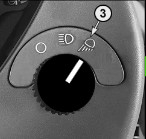 Lighting control switch on dashboard
Lighting control switch on dashboard
Benefits
- Easy to locate and operate
- Small and compact design
Programmable lighting
Overview
The CommandCenter allows operators to customize two different light programs. The operator can switch between the two programs with the push button. Also standard on the 6R Tractors is the battery power-saver feature. When the engine is off and the outside lights have been left on, this feature is designed to avoid battery run-down. After the lights have been left on for 30 minutes and the key is in the off position, the lights will cycle, or blink on and off, five times as an alert. The lights will continue to illuminate for one more minute and then automatically shut off to protect the battery.
 CommandCenter programmable timeout lighting
CommandCenter programmable timeout lighting
 CommandCenter programmable lights page
CommandCenter programmable lights page
 Beacon lights/hazard warning lights, work light 1 and 2 location on right-hand console
Beacon lights/hazard warning lights, work light 1 and 2 location on right-hand console
 Beacon lights/hazard warning lights, work light 1 and 2 location on CommandCenter
Beacon lights/hazard warning lights, work light 1 and 2 location on CommandCenter
Benefits
- The John Deere light programming adds high performance to the operator.
- Individual light selection adds to high operator performance to prevent blinding other operators when two machines are working close to each other.
- Improved uptime due to 360-degree lighting.
More lighting information
Overview
Optional LED lighting technology provides better depth perception and pattern recognition as well as a natural low temperature light for excellent definition of the field. One LED light will out-live 200 or more incandescent lights, 55 or more halogen lights, and 14 or more HID lights.
Beltline and rear fender work lights
Overview
Beltline and rear fender work lights provide options for full light flexibility, giving flood illumination exactly where the operator needs it. The John Deere beltline lights are available with HB3 work lights and LED work lights. The two rear fender lights are available in HB3 or LED.
The John Deere lighting components have undergone numerous vibration testing procedures to ensure a good lighting performance and sturdiness under all conditions.
All work lights and beltline lights are adjustable to a desirable angle.
Two beltline work lights - LED
 Two beltline work lights – LED
Two beltline work lights – LED
Benefits
- Less eyestrain on approaching traffic when traveling on the road.
- Saves the operator on service time and money and minimizes downtime.
- The LED bulbs and diodes have an outstanding operational lifetime to last the tractor's full running lifetime, thus giving the operator greater uptime.
Details
- Mounted at beltline at front of cab.
- No hanging work lights are possible. Not in combination with second beltline lights (873M and 873O).
| Code | Description |
| 873C | Part of Premium panorama roof light package |
873E |
Part of Premium light package |
NOTE: Please also see available attachments.
Two beltline lights - H4
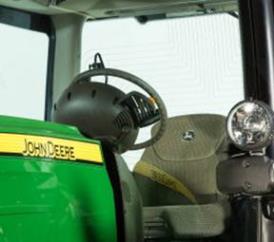 873M - Two beltline lights – H4
873M - Two beltline lights – H4
Benefits
- The two beltline lights provide greater illumination toward the front wheels of the tractor.
Details
- Mounted at beltline at front of cab
- No hanging work lights are possible. Not in combination with second beltline lights (code 873M and 873O).
| Code | Description |
| 873A | Part of Standard panorama roof light package |
| 873F | Part of Standard light package |
NOTE: Please also see available attachments.
Two rear fender work lights – LED
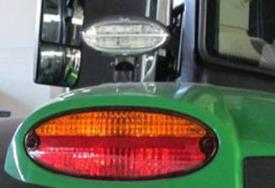 Two rear fender work lights – LED
Two rear fender work lights – LED
Benefits
- The John Deere lighting components have undergone numerous vibration testing procedures to ensure a good lighting performance and sturdiness under all conditions.
- The LED rear fender light adds extra lighting when operating implements close to the ground.
NOTE: These lights should not be operated during road transport.
| Code | Description |
| 873C | Part of Premium panorama roof light package |
| 873E | Part of Premium light package |
NOTE: Please also see available attachments.
Two rear fender work lights – HB3
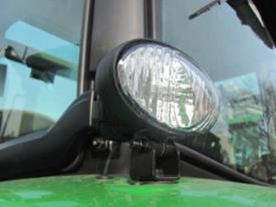 Two rear fender work lights – HB3
Two rear fender work lights – HB3
Benefits
- The two rear HB3 work lights, ensure good performance for the cost-sensitive producer.
NOTE: These lights should not be operated during road transport.
| Code | Description |
| 873A | Part of Standard panorama roof light package |
| 873F | Part of Standard light package |
NOTE: Please also see available attachments.
Beacon light for added visibility
Overview
A beacon light is mounted on the front of the cab to provide a rotating warning light for road traveling and added visibility.
Benefits
- To warn other road users of the presence of a large machine on the road.
- Easily removed with no tools required when approaching height restricted areas.
- Waterproof to ensure good performance when required.
- The beacon has a degree of flexible movement, are not completely static, and can withstand the impact of objects such as tree branches.
Details
- Front cab is roof mounted.
| Code | Description |
| 873A | Part of Standard panorama roof light package |
| 873C | Part of Premium panorama roof light package |
| 873F | Part of Standard light package |
| 873E | Part of Premium light package |
Triple-Link Suspension (TLS™) Plus: More than comfort, it is a performance feature
More productivity - greater operator's comfort
CommandCenter™ console TLS Plus provides exclusive front suspension using a hydropneumatic self-leveling system to increase productivity and improve ride dramatically. TLS Plus provides more control over the front suspension of the tractor. In the field, the TLS Plus front suspension maintains ground-to-tire contact, enabling more power to the ground.
 Front axle adjustment on CommandCenter
Front axle adjustment on CommandCenter
Auto mode
The TLS Plus reacts to inputs, which provides the best comfort and stability. Inputs include travel speed, implement weight, draft characteristics, and braking activity. The TLS Plus activates whenever the tractor exceeds 1.5 km/h (0.9 mph).
Maximum mode
The suspension is set to maximum hardness, which is preferable for front loader operation. This allows the operator to adjust the suspension for different situations. If the tractor exceeds 35 km/h (22 mph), the hardness is reduced to provide greater driving comfort. When dropping below 25 km/h (15 mph), maximum is reactivated.
Manual mode
This setting can be useful when attaching mounted implements to the front hitch. When activated, the axle settles in its mid position and then can be raised or lowered manually with the touchscreen or shortcut buttons F and G. The manual setting is overridden when the travel speed exceeds 5 km/h (3 mph) and returns to the previously selected setting of automatic or maximum.
The system
|
First link: vertical linkage Two double-acting hydraulic cylinders control the vertical movement of the axle, which leads to excellent sensitivity. |
|
Second link: longitudinal linkage |
|
Third link: lateral linkage This third link holds the axle laterally. These few simple components ensure excellent suspension quality and reliability with reduced maintenance. |
A full stroke of the suspension typically takes 1 second, allowing the system time to distinguish between typical terrain inputs or level changes. This prevents overreactions.
In addition to active central leveling of the suspension, the John Deere TLS Plus adopts a constantly variable rod side pressure by using a closed loop system. When the suspension reacts at a different frequency, which could be detrimental to driver comfort, the system then fine-tunes the rod side pressure, changing the spring stiffness and improving the ride behavior.
*Not available in 6155RH
ISOBUS and tractor-baler automation offer new baling experience
Tractor-Baler Automation simplifies baling experience
 A single manual action; system manages the rest
A single manual action; system manages the rest
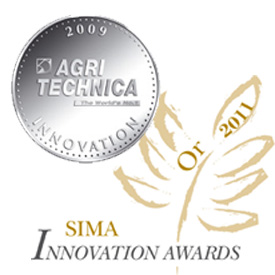 TBA awards
TBA awards
The optional Tractor-Baler Automation (TBA) makes baling easy. This exclusive system manages most of the baling process and gives the customer the following advantages:
- High baling comfort a single action to bale instead of four.
- Error proof baling - even after 10 working hours, the system does not forget any action; a true advantage for an inexperienced driver.
- Constant bale quality - same diameter bale after bale
- Constant productivity - no reduced efficiency due to operators fatigue.
When used with a John Deere ISOBUS tractor, electric selective control valve (E-SCV), and (IVT™) transmission, the system will be able to:
- Stop the tractor when bale size is reached
- Wrap the bale
- Open the gate
- Close the gate when bale is unloaded
The only action remaining is to forward reverser and manage the steering.
If the John Deere tractor is not equipped with IVT but has E-SCV and ISOBUS, opening and closing can be automated.
A single touch on SCV, brakes, or reverser will disengage the automation. In the same way, automated open/close can be momentarily stopped when unloading in hilly conditions.
Tractor-Implement Automation is an exclusive green on green advantage. This advanced technology option has won awards at SIMA and Agritechnica farm equipment show in Europe, a true cost/value guarantee.
NOTE: to run through fully automated mode, a John Deere Isobus tractor with E-SCV and IVT is required. A baler activation key and a tractor activation key (different) have to be ordered.
ISOBUS certified balers
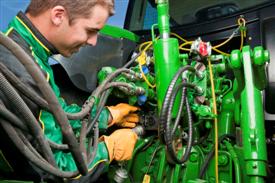 Plug in and bale with ISOBUS
Plug in and bale with ISOBUS
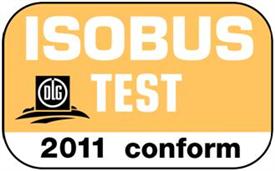 ISOBUS certified = compatibility guarantee
ISOBUS certified = compatibility guarantee
The 990 and 960 Balers offer ISOBUS compatibility as base equipment. This standardized communication not only allows the use of John Deere Greenstar2 1800, 2600, or 2630 Displays, but also the use of other ISOBUS conform competitive monitors.
Adapter harnesses for non-ISOBUS tractors are available.
User friendly interface
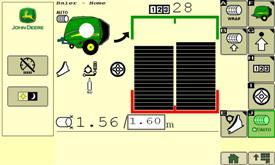 Main page with simple and clear pictograms
Main page with simple and clear pictograms
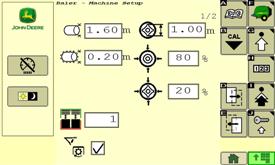 Bale or soft core density adjustments
Bale or soft core density adjustments
The Baler interface displays information that is needed. The 900 Series monitors provide all required information:
- Bale shape and diameter
- Drop floor and knives position
- Variable core activation
- Tying process status
- Gate position
- Maintenance status
Adjustments can also be managed from the operators station:
- Bale size and density
- Variable core diameter and density
- Net and twine tying parameters
- Knife selection
- Automated lubrication
- Tractor-Baler Automation status
- Bale counter resets
Greenstar™2 1800 has the ideal display for baling application
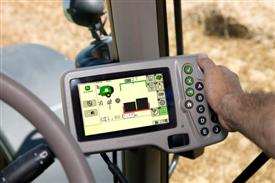 Greenstar2 1800 Display ordered with the baler
Greenstar2 1800 Display ordered with the baler

The 900 Series Balers can be teamed with all ISOBUS certified displays. The Greenstar2 1800 monitor can be ordered with the baler to match traditional baling requirements. When not baling this display can be used for other functions such as guidance and spraying applications when connected to an appropriate receiver and implement.
All ISOBUS display will fit the 900 Series
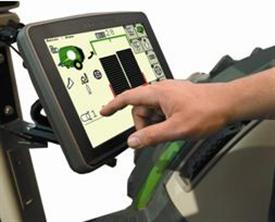 GreenStar3 2630 fits the most demanding user needs
GreenStar3 2630 fits the most demanding user needs

The 960 and 990 Balers can be ordered without a monitor for customers who already have an ISOBUS display, or for those who search more advanced application (field management). Displays other than John Deere Greenstar2 1800 can be purchased through Ag Management Solutions (AMS) pages.
Features
CommandCenter™ display
Overview
The Generation 4 CommandCenter creates the primary user interface for 6R Series Tractors. The Generation 4 CommandCenter provides an excellent, user-savvy operating experience.
Producers can also use a variety of implements with the Generation 4 CommandCenter as it is ISOBUS virtual terminal (VT) capable.
Expect machine productivity gains, along with increased operator confidence, thanks to a simple, customizable interface. The reliability of the Generation 4 CommandCenter also aids in optimal operating experience and maximizes uptime.
 4200 CommandCenter 21.3-cm (8.4-in.) display
4200 CommandCenter 21.3-cm (8.4-in.) display
 4600 CommandCenter 25.4-cm (10-in.) display
4600 CommandCenter 25.4-cm (10-in.) display
Benefits
- Easy-to-change fields and guidance lines
- Custom-defined views
- On-screen help functions
- Intelligent warnings
- Context-based help
Details
| Code | Description |
| 1947 | 4200 Processor (21.3-cm [8.4-in.] display only) |
| 1946 | 4600 Processor (25.4-cm [10-in.] display only) |
| Code | Description |
| 1829 | 21.3-cm (8.4-in.) CommandCenter display (4200 Processor only) |
| 1822 | 25.4-cm (10-in.) CommandCenter display (4600 Processor only) |
| Code | Description |
| 1867 | Less application |
| 1851 | CommandCenter AutoTrac™ activation |
| 1858 | 4200 Section Control and Data Sync activation plus CommandCenter AutoTrac activation |
| 1857 | 4600 CommandCenter Premium Activation 3.0 |
| 1861 | 4600 CommandCenter Automation Activation 1.0 |
| 186S | 4600 CommandCenter Automation Activation 3.0 |
NOTE: CommandCenter AutoTrac activation stays with the tractor.
NOTE: 6155RH only available with code 1867.
 Help center main page
Help center main page
Additionally, application-based help is also available in all locations of the CommandCenter. Simply click on the (i) icon available on the title bar and it will lead directly to more information on the application currently being used.
Display options
Generation 4 CommandCenter displays are available in the following configurations:
- 21.3-cm (8.4-in.) display on the 4200 CommandCenter
- 25.4-cm (10-in.) display on the 4600 CommandCenter
For those wanting to maximize their viewing real estate, the 25.4-cm (10-in.) touchscreen color display is an excellent choice. With the 25.4-cm (10-in.) display, the title bar and all shortcut keys may be viewed at all times. Operators can monitor more items at once on the 25.4-cm (10-in.) touchscreen display.
Layout Manager
 Layout Manager selection page
Layout Manager selection page
 Layout Manager module build
Layout Manager module build
The Generation 4 CommandCenter features a modular-designed layout manager so an operator can easily create the structure that meets the operator’s demands. From the factory, machines are equipped with standard run pages. An unlimited amount of run pages can be added to the Generation 4 CommandCenter based on operator preference or operational needs. Toggling between run pages is as easy as swiping the screen or using the arrow buttons on the top right portion of the title bar.
Users and access
Users and access allow the owner to lock out certain functions to prevent operators from accessing or changing settings. Lock-out functions are managed with an owner-defined four-digit code.
Lockout features are available for:
- Precision Ag Technology applications
- Hitch
- Hydraulic
- Transmission
- Power take-off (PTO)
- FieldCruise™ engine controls
- Display
- Machine monitor
On-screen help and diagnostic text
There are a number of different ways to get meaningful on-screen help when navigating the Generation 4 CommandCenter. Operators can find the help icon on the shortcut bar on the bottom of every page. This icon gives detailed information on everything from tractor operation to application information. Simply select the help icon and navigate to the information section that is needed.
Work monitor
 Work monitor page
Work monitor page
The work monitor application displays the performance information about the task being performed by the machine. The user is shown averages, totals, and productivity of the machine, such as area worked, average working speed, and fuel usage. The values of the work monitor can be reset by the user at any time. Specific values of the work monitor can be configured by the user to be shown on a run page.
NOTE: The work monitor application replaces part of the universal performance monitor in previous machines.
Video capability
Tractors with a 4200 CommandCenter are equipped with one video input and tractors with a 4600 CommandCenter have two video inputs. The operator has the ability to set a variety of triggers, including reverse, PTO, hitch, and selective control valve (SCV) levers to activate the camera. The image will then appear on the CommandCenter display. The camera (video observation system) is available through JD Parts and Ag and Industrial (A & I) Products.
John Deere Generation 4 CommandCenter processors
A Generation 4 CommandCenter is made up of a processor and a display. Two processor options are available for the Generation 4 CommandCenter.
The 4600 Processor is the premium processor. Available features with the premium processor include:
- Compatible with 25.4-cm (10-in.) touchscreen display
- Two video camera inputs
- One USB input
- AutoTrac capable (machine-specific activation sold separately)
 Context-based help iTEC™ main page
Context-based help iTEC™ main page
Diagnostic text and information is available for better understanding of whether applications are operating as directed.
Machine monitor
 Machine monitor page
Machine monitor page
The machine monitor application provides the user instantaneous readings about the status or condition of the machine. Values shown in the machine monitor vary by application, but typically include parameters like engine speed, coolant temperature, and ground speed. The machine monitor supports run page modules in the layout manager, allowing the user to populate specific machine parameters directly to a run page.
NOTE: The machine monitor application replaces part of the Universal Performance Monitor in previous machines.
 25.4-cm (10-in.) 4600 CommandCenter display
25.4-cm (10-in.) 4600 CommandCenter display
The 4200 Processor is base equipment on all 6R Tractors. It offers:
- Compatible with 21.3-cm (8.4-in.) touchscreen display
- One video camera input
- One USB input
- AutoTrac capable (machine-specific activation sold separately)
| Tractors | 4600 Processor | 4200 Processor |
| 6R | Option | Standard |
 John Deere 4200 CommandCenter
John Deere 4200 CommandCenter
A. Next run page
B. Status center
C. Expand shortcut keys
D. Menu
E. Run page
 John Deere 4600 CommandCenter
John Deere 4600 CommandCenter
A. Next and previous run page
B. Status center
C. Shortcut keys
D. Menu
E. Run page
F. Title bar
Infinitely Variable Transmission (AutoPowr™/IVT™) system
Overview
The John Deere Infinitely Variable Transmission (AutoPowr/IVT) utilizes a combination of mechanical and hydrostatic power, providing stepless and continuous power across an infinitely variable range of speeds.
Single-speed lever is used for intuitive and accurate control of ground speeds as slow as 50 m/h (0.03 mph) to 40/50 km/h (25/31 mph). In model year 2015, the transmission was revised so transport speeds are reached at lower engine rpms, ultimately reducing fuel consumption and in cab noise. Software has also been revised to ensure under acceleration engine rpm is kept to a minimum within the engines peak torque band.
 AutoPowr/IVT transmission
AutoPowr/IVT transmission
Benefits
- Easy to operate
- Four mechanical modes lead to excellent performance and reduced fuel consumption
- Revised ratios bring transport speeds at reduced engine rpm – reduced fuel consumption and increased comfort
- Precise management of forward speeds
- Less shifting time means better management of the implement
Details
- Requires 240-amp alternator (code 8743) (6110R, 6120R, and 6130R)
- Requires code electrohydraulic (EH) selective control valves (SCVs) and 240-amp alternator
- Requires braked front axle (code 6070)
- Requires hydraulic trailer brakes (code 8756)
- Requires B-speed rated tires and front fenders (8011 or 8012)
NOTE: Not available in 6155RH.
| Code | Description |
| 1552 | AutoPowr/IVT – 50 km/h (31 mph) |
Details
- Requires code EH SCVs
- Requires 240-amp alternator (code 8743) (6110R, 6120R, and 6130R)
NOTE: Not available in 6155RH.
| Code | Description |
| 1551 | AutoPowr/IVT – 40 km/h (25 mph) |
50 km/h (31 mph)
 6R in transport
6R in transport
The following features are part of the 50 km/h (31 mph) package:
- Triple-Link Suspension (TLS™) Plus system with brakes for improved braking capacity
- Rim and tire matching with fixed tread rims to minimize vibration and increase ride comfort
- Trailer brakes
- Front and rear fenders
Set-speed adjusting wheel
Overview
The set-speed adjusting wheel is the rotational thumbwheel located on the speed control lever. The wheel is quick and easy to adjust with the operator’s thumb and rotates infinitely with no stop or start position. When the operator rotates the thumbwheel, the ground speed of the tractor is increased by 0.2 km/h (0.12 mph) when the tractor is traveling below 20 km/h (12 mph). When the tractor is traveling above 20 km/h (12 mph), the tractor is increased by (1) km/h (0.6 mph). The set speed adjuster is used to set the maximum commanded forward or reverse speed in each speed band.
As the operator moves the lever within or between speed bands, the electronic management system ensures smooth, quick, and powerful acceleration or deceleration, regardless of load or ground speed.
While in motion, the operator can adjust the maximum speed of each speed band. With the lever in band one, the target maximum speed can be adjusted to 20 km/h (12 mph). With the lever in band two, the maximum speed of 40/50 km/h (25/31 mph) can be defined depending on transmission option. When stationary, all set speeds, both forward and reverse, may be adjusted while the left-hand reverser is in the power zero position.
 Thumbwheel located on the speed control lever
Thumbwheel located on the speed control lever
 Lever slot between speed brands
Lever slot between speed brands
 Left-hand reverser
Left-hand reverser
For tractors with CommandPRO, the left-hand reverser incorporates only forward and reverse direction selection and the lever is self-centering. The park (P) and neutral (N) positions can be selected on the CommandPRO.
 Full auto screenshot on CommandCenter display
Full auto screenshot on CommandCenter display
Custom mode
Overview
Custom mode allows the operator to customize the AutoPowr/IVT transmission settings when full auto mode is not desirable. In custom mode, operators can turn ECO on and off. This can either be done by pushing the ECO button on the side of the hand throttle module or by selecting ECO in the transmission settings page of the CommandCenter display. When accelerating with ECO on, the tractor minimizes engine speeds, which reduce acceleration aggressiveness. As a result, ECO on should reduce fuel consumption in lighter, steady loads. In contrast, when accelerating with ECO off, engine speed can be higher aggressively to maximize productivity. The higher engine speeds with ECO off better enable the tractor to quickly recover from sudden load increases and not lose as much ground speed when load increases occur.
In custom mode, the engine droop settings can be defined between 4 percent and 30 percent with PTO on and off. The higher the droop percentage, the more the engine rpm will be reduced when pulling before a transmission ratio change is made.
 Drop-down information for set speeds on CommandCenter™ display when rotating the thumbwheel
Drop-down information for set speeds on CommandCenter™ display when rotating the thumbwheel
 Set speed indicated in the dashboard
Set speed indicated in the dashboard
Benefits
- Quick and precise speed changes
- Fine-tuning via the speed wheel
- Two steps in the slot of the speed control lever to program two set speeds
- Speed feedback on the analog dashboard – the needle shows the actual speed, and red lights around the needle show the commanded speed
- Easy-to-handle exact-speed settings through the CommandCenter display and the speed wheel
Left-hand reverser
Overview
An easy-to-use left-hand reverser is available in all the AutoPowr/IVT transmissions. The reverser control is located at the 10 o’clock position on the steering column for intuitive control. For tractors without the CommandPRO™ joystick, the left-hand reverser incorporates the following controls:
- Forward direction selector
- Reverse direction selector
- Park (P) - Park lock (P) - Tractor cannot move and the trailer brakes are engaged. Lever must be in the (P) park position to start the tractor.
- Neutral (N) – Tractor is in a non-parked position and capable of movement.
- Power zero – Tractor is held stationary by the transmission.
 Left-hand reverser if equipped with CommandPRO
Left-hand reverser if equipped with CommandPRO
Benefits
- Tractors without CommandPRO allow for temporary stationary control of the tractor without using the brakes. For tractors with CommandPRO, ActiveZero is always in place when the tractor is not in N or P and brakes are not applied.
- Quick and easy way for the operator to change the direction of the tractor.
- Ensures that the tractor cannot be operated with the park lock on.
Electronic hand and foot throttle
Overview
The tractor ground speed is controlled via the accelerator and hand throttle. The engine rpm can be set to a specific ground speed using the hand throttle (A). The following functions are available for tractors without CommandPRO:
- Button (B) activates and de-activities the FieldCruise™ system (with two available pre-sets), which is an engine rpm limiter.
- The specific ground speed set can be set by pressing button (C); this pedal lock feature works like the cruise control on a car (only functions when foot throttle is ordered).
- Button (D) allows the operator to drive with the minimum target rpm with ECO on.
- NOTE: Button (D) is only active in custom mode.
 Hand throttle
Hand throttle
The following functions are available for tractors with CommandPRO:
- Button (B) and (D) activate and de-activate engine set speeds that can be set in the CommandCenter display.
- Button (C) can be used to fix the engine speed command to the current hand throttle position (no automatic engine speed control).
 Hand throttle when equipped with CommandPRO
Hand throttle when equipped with CommandPRO
 Foot throttle
Foot throttle
Benefits
- Define setting of the engine speed and its limit with the FieldCruise system
- Quick attainment of desired speed
- Pedal lock function allows command foot throttle speed to be maintained
AutoPowr/IVT selector control via CommandCenter display
Overview
The AutoPowr/IVT application setting employs four modes to take full advantage of the engine-transmission communication: full AUTO, custom, pedal and manual.
Full AUTO mode
Overview
Full AUTO mode enables the tractor to make adjustments to the transmission operating mode automatically, based on the engine and transmission speeds and the load on the tractor. This should be the AutoPowr/IVT transmission setting for 95 percent of all applications.
Full AUTO mode switches between load control and fuel economy mode seamlessly, with no involvement from the operator, as conditions and applications change. Fuel economy mode automatically switches off when the power take-off (PTO) is engaged to provide full PTO power. Operators can set the maximum forward and reverse speeds for the tractor in their particular application.
NOTE: Activation ECO is not available in full auto mode.
 Pedal mode display on CommandCenter display
Pedal mode display on CommandCenter display
Benefits
- Pedal mode is ideal for applications like mowing, baling, or hedge cutting, where it is important to keep the engine speed at a constant rpm independent from the ground speed.
Manual mode settings
Overview
Manual mode makes the transmission and engine independent of each other. The transmission does not automatically adjust engine rpm to save fuel. This can prove to be useful in applications like loader work, where the variability of engine speed based on load is not needed.
 Load anticipation display on CommandCenter display
Load anticipation display on CommandCenter display
Benefits
- John Deere exclusive feature
- Tractor recognizes when additional engine rpm is needed
- Saves fuel, because the engine shuts down when no additional power is needed
Forward/Reverse relationship
Overview
Similar to the AutoQuad™ PLUS transmission, the AutoPowr/IVT transmission can also adjust the forward/reverse speed ratio. The reverse speeds can be set to a maximum of 30 percent higher and 70 percent lower than forward speeds, but only in range 1. In range 2, the forward-to-reverse speed ratio is 1:1, up to 22 km/h (14 mph). Above that, the reverse speeds will only go up to 30 km/h (19 mph).
 Section of forward/reverse relationship via CommandCenter display
Section of forward/reverse relationship via CommandCenter display
Brake with integrated AutoClutch function
Overview
With the AutoPowr/IVT transmission, no clutching is required to stop the tractor. After the brakes are released, the tractor automatically accelerates back to its previous speed (if using hand throttle). The effect of AutoClutch can also be set via the CommandCenter display.
 Operator presses brake pedal to stop the tractor
Operator presses brake pedal to stop the tractor
 AutoClutch sensitivity change on CommandCenter display
AutoClutch sensitivity change on CommandCenter display
Benefits
- This feature makes the AutoPowr/IVT an ideal transmission for operations that require a lot of speeds (like baling or loader work).
- Upon release of the AutoClutch, the tractor will accelerate to the previous command speed (ideal for round baling).
- Excellent modulation makes inching to implements and attachments easy.
Torque
Overview
The AutoPowr/IVT transmission is a combination of mechanical and hydraulic components that are capable of providing low speed with extremely high levels of torque:
- Allows the tractor to smoothly pull away, even under high loads
- Enhances front loader operation by delivering high torque, driving the tractor into the pile without slippage
- Retains constant working speeds with PTO implements, which have a tendency to push the tractor (spading or rotary cultivator)
Creeper mode
Creeper mode is a standard feature on the AutoPowr/IVT transmission. Down to 50 m/h (164 ft/h), the creeper mode is activated when the selected speed is below 2.1 km/h (1.3 mph) in set position 1.
When the tractor moves below 600 m/h (1968 ft/h), the engine speed is independent of travel speed. This allows the operator to choose the engine speed that best fits the task (rated speed for hydraulic or PTO usage, or low idle for fuel-saving operation). No additional power is needed.
 Customizing speed of direction on CommandCenter display
Customizing speed of direction on CommandCenter display
 Droop setting on CommandCenter screen
Droop setting on CommandCenter screen
Benefits
- Ensure that the operator has the best driving options when required
- Independent droop settings allow the operator improved performance and flexibility
Pedal mode settings
Overview
Pedal mode allows the operator to change the tractor’s ground speed independently from the engine speed. The ground speed is controlled through use of the foot pedal while the hand throttle determines engine speed. Maximum ground speed is determined by the location of the speed control lever in the speed band. Operators can lock-in a desired ground speed without pressure on the foot pedal using the pedal lock button (as described above). To unlock the foot pedal, the operator can tap the foot pedal, press the lock button, or press the brake pedal. When releasing the foot pedal, the vehicle decelerates to a safe creep speed. To come to a complete stop, the brake pedal should be depressed.
 Manual mode display on CommandCenter display
Manual mode display on CommandCenter display
Load anticipation feature
Overview
The load anticipation feature allows the AutoPowr/IVT transmission to predict how much load the engine expects from the activation of the hitch or a particular SCV function.
In full AUTO mode, all load anticipation features are active. In custom mode, they can be turned on or off in the custom settings page. When an SCV or the hitch is activated, the engine speed is raised to 1500 rpm (as long as the commanded throttle position is over this value). This creates a boost in engine power which improves hydraulic performance and prepares the engine for potential load situations (for example, returning an implement to work). Also added is PTO load anticipation. If it is turned off, the engine does not react to PTO engagement and engine speed is controlled purely based on load. If turned on (in custom), when the PTO is engaged, the engine rpm will rise to throttle position or pre-defined PTO cruise setting.
Rear-mounted selective control valves (SCVs)
Overview
To control a rear implement, up to six SCVs or five SCVs plus Power Beyond can be ordered (6145R-6250R). For (6110R- 6130R) up to five SCVs or four SCVs plus Power Beyond can be ordered. The SCVs can be controlled electrically. Up to four mechanical SCVs are available, in combination with Power Beyond. All mechanical or electrical SCVs feature four positions - neutral, raise, lower, and float.
Benefits
- Release levers make disconnecting hydraulic hoses easy
- Relocated valves improve operator's visibility to the rear hitch
- Up to six rear SCVs give operators total flexibility
| Code | Description | Information | Availability |
| 3312 | Two mechanical SCVs – premium | Premium couplers with high-pressure relief lever. Two mechanical SCVs 450 Series. Only in combination with PowrQuad™ Plus transmission or AutoQuad™ Plus transmission. Only available on 6110R - 6130R. |
6110R, 6120R, 6130R |
| 3332 | Three mechanical SCVs - premium | Premium couplers with high-pressure relief lever. Only in combination with PowrQuad Plus or AutoQuad Plus. | 6110R, 6120R, 6130R, 6145R, 6155R, 6175R, 6195R, 6215R |
| 3311 | Two electronic SCVs - premium | Premium couplers with high-pressure relief lever. | 6110R, 6120R, 6130R |
| 3331 | Three electronic SCVs - premium | Premium couplers with high-pressure relief lever. | 6110R, 6120R, 6130R, 6145R, 6155R, 6175R, 6195R, 6215R, 6230R, 6250R |
| 3341 | Four electronic SCVs - premium | Premium couplers with high-pressure relief lever. | 6110R, 6120R, 6130R, 6145R, 6155R, 6175R, 6195R, 6215R, 6230R, 6250R NOTE: Not available for 6155RH. |
| 3351 | Five electronic SCVs – premium | Premium couplers with high-pressure relief lever. When ordered with right-hand console, (code 2055) also electrical joystick (code 841L) for operation of rear SCVs or electrical midstack SCV (code 8922, 8923, 8914 or 8915) is required. A maximum of four SCVs can be operated via paddle pot at right-hand console. | 6110R, 6120R, 6130R, 6145R, 6155R, 6175R, 6195R, 6215R, 6230R, 6250R NOTE: Not available for 6155RH. |
| 3361 | Six electronic SCVs – premium | Premium couplers with high-pressure relief lever. Not with right-hand console (code 2055). Not in combination with electrical joystick (code 841L) and any option with electrical joystick. | 6145R, 6155R, 6175R, 6195R, 6215R, 6230R, 6250R NOTE: Not available for 6155RH. |
Mechanical control valves
Overview
The tractor may be equipped with one type of mechanical control valves: premium (450 Series).
Premium-couplers control valves also have an additional lock function (position 3), which holds the control lever in the raise or lower position until the pressure in the oil circuit has reached a predetermined value (e.g., when the control cylinder has reached its end position).
In position 2, the control lever returns to neutral as soon as it is released and is the setting for normal hydraulic operation.
If an implement is connected, pressure connection has to be connected to the lower coupler. With standard SCVs, a valve prevents sudden loss of pressure caused by leakage when the engine is shut off.
On premium SCVs, the likelihood of leakage is further diminished.
 Premium mechanical control valve (premium)
Premium mechanical control valve (premium)
- Position 1
- Position 2
- Position 3
- Hydraulic oil flow control
Electrical control valves
Overview
The tractor may be equipped with the premium (450 Series) control valves. All main characteristics can be controlled by the CommandCenter™ display.
 CommandCenter hydraulics option
CommandCenter hydraulics option
Example options of rear valve configuration
 3351 – five electronic SCVs (five SCV premium)
3351 – five electronic SCVs (five SCV premium)
 3361 – six electronic SCVs (six SCV premium)
3361 – six electronic SCVs (six SCV premium)
Hydraulic control options
 E-SCV controls on the right-hand console
E-SCV controls on the right-hand console
 M-SCV controls on the right-hand console
M-SCV controls on the right-hand console
 E- SCV controls on CommandARM™ controls
E- SCV controls on CommandARM™ controls
 E-SCV controls on optional joystick (reconfigurable)
E-SCV controls on optional joystick (reconfigurable)
Hydraulic set up
Shortcut button right-hand console
Overview
Simply push the hydraulic symbol on the right-hand side console or the CommandCenter and the CommandCenter display shows a setup menu to:
- Monitor valve status - detent, float, or neutral
- Adjust maximum flow and detent (combine for both direction or separate extent and retract adjustment)
 Hydraulic shortcut button on right-hand console
Hydraulic shortcut button on right-hand console
 Hydraulic shortcut button CommandCenter
Hydraulic shortcut button CommandCenter
Detent setup
Overview
- Time detent - this is particularly useful when repeat SCV operations are performed, such as lowering a mower-conditioner plow or cycling planter markers.
- Continuous flow detent - this is particularly useful when a hydraulic motor is used, such as on an air seeder.
 Detent setup
Detent setup
SCV flow setup
Overview
SCV flow rate can be programmed between 0.04 and 10 allowing fine tuning for implements with different hydraulic requirement.
Behavior can be set between linear (red), progressive (green), or a combination (yellow) for exact flow modulation and precise valve management.
- Linear means that the distance travelled by the SCV/ICV corresponds to the distance travelled by the control lever/multifunction lever
- Progressive means that initially the distance travelled by the SCV/ICV is less than that travelled by the control lever/multifunction lever (giving a more sensitive start to the movement)
 Flow setup
Flow setup
 Three flow options
Three flow options
 Flow characteristic setup
Flow characteristic setup
Combination is an intermediate stage between the two settings listed above.
CommandPRO™ joystick driving strategy
The optional CommandPRO joystick combines a unique driving strategy with reconfigurable controls.
 CommandARM™ controls with CommandPRO
CommandARM™ controls with CommandPRO
Layout and functions
 |
1 – travel set speed buttons 1 and 2 |
 |
4 – reconfigurable buttons and rocker switches (buttons 10 and 11, rocker switches C and D) |
Benefits
- 11 reconfigurable controls for both tractor and implement functions
- Possibility to operate tractor and ISOBUS functions at the same time on the CommandPRO joystick
- Intuitive and easy driving concept
| Code | Description |
| 2089 | Standard Cab with CommandPRO |
| 2091 | Premium Cab with CommandPRO |
| 2092 | Premium Cab with CommandPRO and cab suspension |
Default assignments

| Rocker D: selective control valve (SCV) II (if equipped) | Button 10: engine set speed 1 |
| Rocker C: SCV I (if equipped) | Button 11: engine set speed 2 |
| Rocker B: front hitch (if equipped) | Button 12: AutoTrac™ resume (if equipped) |
| Rocker A: rear hitch (if equipped) |
NOTE: For information about reconfigurability, please see operator's station functional area.
Driving strategy
The unique driving strategy is designed to deliver highest performance in combination with operator comfort making the daily work much easier and efficient.
- Pedal and joystick mode are active at the same time
- ActiveZero keeps the output speed actively at 0 km/h (0 mph) until command for acceleration is given independent of load or engine speed
- Command top and zero speed simply by one push or pull
- Unique inching control
- Three easily adjustable travel set speeds
- Two engine set speeds
- Three acceleration response settings
 Driving strategy
Driving strategy
| Forward movement | Reverse movement | |
| 1 | Accelerate | Decelerate |
| 2 | Top set speed | Zero speed |
| 3 | Decelerate | Accelerate |
| 4 | Zero speed | Accelerate |
| 5 | Activate set speed | |
| 6 | Select direction | |
| 7 | Inching speed | |
| 8 | Inching speed | |
 CommandPRO joystick driving functions
CommandPRO joystick driving functions
Pedal and joystick mode active at the same time
The change between using the foot pedal or the joystick can happen while driving for ease of use and comfort. The simple rule is: the higher speed command is superior. When changing from the pedal to the joystick, there is a short overlap where the joystick takes over the command from the pedal before the pedal is released. Similar, when changing from joystick control to the foot pedal, the driver needs to push the foot pedal to the point of speed where the joystick is before it can take over.
Inching control
The inching control of the CommandPRO joystick simplifies the attachment of implements. Once the joystick is pushed into the inching range, the tractor moves very slowly in the selected direction. Speed is dependent on the joystick position and can be speed between 0 and 2 km/h (0 and 1.2 mph). Maximum speed of the inching range can be set to 5 km/h (3.1 mph) with the travel speed adjustment wheel.
Unlike the main range, releasing the joystick means the speed is reduced until the vehicle stops completely. This allows the operator to fully focus on the implement and quickly stop if required.
 Inching control on CommandPRO joystick
Inching control on CommandPRO joystick
Travel set speeds
The travel set speed buttons on the CommandPRO joystick allow the operator to set two set speeds. The operator has to preselect the desired set speed by pushing the travel set speed button 1 or 2 and once the joystick is pushed to the right, the set speed is activated and the travel speed will be adjusted until the set speed is achieved. Additionally, the operator can set a maximum travel speed through the travel speed adjustment wheel or in the CommandCenter™ display.
There are different ways to set or adjust the set speeds:
- In the CommandCenter display
- If current travel speed should be saved as a set speed, press and hold either one of the buttons for 2 seconds and the speed is saved
- When already using a set speed, it can be adjusted with the travel speed adjustment wheel
The operator can also set a dedicated set speed when changing the travel direction. For example, the tractor is driving forward at 10 km/h (6.2 mph) and for reversing the reverse shuttle shift speed is set to 5 km/h (3.1 mph). This means when the shuttle shift takes place, the tractor will accelerate to 5 km/h (3.1 mph) in reverse direction. This function can be turned on/off and set to the dedicated speed in the CommandCenter display.
 Set speeds and shuttle shift speeds in the CommandCenter
Set speeds and shuttle shift speeds in the CommandCenter
Acceleration response
The three settings for acceleration and deceleration with the CommandPRO joystick can be changed by pressing acceleration response button. Three light-emitting diodes (LEDs) next to the set button indicate the currently activated setting.
- Smooth acceleration and deceleration – one LED glows
- Normal acceleration or deceleration – two LEDs glow
- Rapid acceleration and deceleration – three LEDs glow
 Three settings for acceleration and deceleration
Three settings for acceleration and deceleration
The settings influences the following:
- Characteristics of increase and decrease in speed for both CommandPRO joystick and foot pedal
- Speed change value when flicking the CommandPRO lever forward or backward (triggering).
- 0.2 km/h (0.12 mph) in slow acceleration mode
- 0.5 km/h (0.31 mph) in normal acceleration mode
- 1 km/h (0.62 mph) in rapid acceleration mode
- Acceleration characteristics when activating a travel set speed
- Tractor behavior when commanding a change in direction of travel
To ensure comfortable and reliable deceleration of the tractor with both the foot pedal and the CommandPRO joystick the tractor is equipped with unique technology. The engine overspeed protection ensures that both transmission and engine are not overloaded when decelerating. Additionally, the anti-jackknife technology compares wheel speed of front and rear wheels when decelerating through the joystick, as this means that the front brakes are not applied but only through the rear axle. If the front wheels are moving quicker, the transmission automatically adjusts to ensure the same wheel speed and avoid the jackknife situation.
Park lock and neutral
The park lock is disengaged automatically when commanding any direction of travel. Additionally, it engages automatically when the driver leaves the driver seat while the tractor is stationary. If the tractor is equipped with a trailer brake, this logic also applies for the trailer brake.
The buttons for the park lock and neutral position are next to the CommandPRO joystick on the CommandARM controls. There is no park lock or neutral position available in the left-hand reverser.
 CommandPRO joystick with neutral and park position
CommandPRO joystick with neutral and park position
ComfortView™ cab operator environment
Overview
ComfortView cabs feature a modern, automotive-style instrument panel as base equipment. The instrument pod has two large analog dials for engine and tractor speed, as well as two smaller dials that display fuel level, diesel exhaust fluid (DEF) level, and coolant temperature. The steering column and dash are adjustable to suit the operator's needs. The column tilts toward the operator and a lever on the left-hand side allows for the column to telescope out to the desired level.
A dimming mode automatically reduces the brightness of the instrument illumination when the tractor lights are used.
Steering column control panel
 Cab and controls of 6R Tractor
Cab and controls of 6R Tractor
 Steering column on 6R Tractor
Steering column on 6R Tractor
Instrumentation control panel
Overview
The instrumentation panel has a row of information and warning lights across the bottom to monitor all important tractor functions. A three-stage warning system first gives information, then gives warnings, and finally, gives a stop alarm to prevent damage from occurring in the event of a component malfunction. An integrated power take-off (PTO) over-speed warning is incorporated into the diagnostics to ensure proper operation.
 Instrumentation control panel
Instrumentation control panel
Dash instrument panel controls include:
| Left side | Right side |
| Left-hand reverser | Two-speed and optional intermittent wiper |
| High-/low-beam switch | Key start/stop |
| Hazard switch | Road/work lights on/off |
| Self-cancelling turn signals/horn |
In-cab storage
 Overhead storage compartment
Overhead storage compartment
 CommandARM™ console storage compartment
CommandARM™ console storage compartment
CommandARM controls
Overview
The 6R Series features a redesigned CommandARM console with all key vehicle functions in one place. The updated CommandARM layout is only available with Infinitely Variable Transmission (IVT™) and DirectDrive transmissions. The base 21.3-cm (8.4-in.) 4200 CommandCenter™ Display or optional 25.4-cm (10-in.) (4600 CommandCenter Display is fully integrated onto the CommandARM and offers fast adjustment of additional tractor functions.
The CommandARM design allows for 37.5 degrees of total seat swivel and adjustable positioning matching the operator’s preference. (30 degrees right and 7.5 degrees left).
Hydraulic and hitch controls utilize fingertip paddle pots for raise/lower and extend/retract functions. The CommandARM offers up to a maximum of six electronic selective control valves (E-SCVs) (without electronic joystick). The optional electrical joystick replaces fingertip paddle pots for control of selective control vales (SCVs) and allows for programmable hydraulic functionality according to operator preference. A maximum of five E-SCVs can be ordered with the electronic joystick. For tractors with an IVT transmission, the CommandPRO™ joystick is available. Its 11 reconfigurable buttons enable the operator to have all necessary controls accessible without hand movements (for details, click here).
Controls for radio, lights, rotary beacon, and hazard flashers are located to the center right on the CommandARM along with PTO for front (if equipped) and rear PTO. Additionally, located on the right side of the CommandARM is an encoder wheel which allows for finite positioning of the rear 3-point hitch. There are three buttons near the encoder for set lock and return to height. Adjustment knobs for the 3-point hitch are located under the cover for the CommandARM storage compartment and allow for adjustment of the rate of drop, hitch height limit, and depth control.
The transmission control and throttle are placed on the left side of the CommandARM closest to the operator for convenient setting and adjustment. The throttle design incorporates buttons which control engine cruise speed, pedal lock/cruise control, and transmission Eco settings (for more information, refer to the AutoPowr™ or DirectDrive transmissions pages).
Located just to the right of the throttle is the auto-steer activation button and four sequence controls for iTEC™ functions. Behind the iTEC sequence controls are buttons which control the activation and deactivation of mechanical front-wheel drive (MFWD) and differential lock.
Differential lock can also be activated by foot switch on the cab floor. A feature in the 6R Series Tractor is auto steering angle dependent differential lock button.
Operators can easily identify controls by icons located near levers, and each functional area is color coded.
Functions:
- Motion (throttle, transmission) - orange
- MFWD and hydraulics (hitch and SCVs) - black
- PTO - yellow
 ComfortView cab with CommandARM console
ComfortView cab with CommandARM console
 Close up of controls on the CommandARM
Close up of controls on the CommandARM
 Optional integrated crossgate joystick
Optional integrated crossgate joystick
 CommandPRO controls (IVT only)
CommandPRO controls (IVT only)
 Hand throttle feature
Hand throttle feature
 3-point hitch control layout
3-point hitch control layout
 Integrated differential lock features
Integrated differential lock features
Benefits
- All main tractor functions in one place
- Hand throttle module with integrated cruise control/pedal lock and Eco function
- Integrated reconfigurable joystick
- All controls and display move with the operator's movement or motion
- Availability of optional 25.4-cm (10-in.) 4600 CommandCenter Display
- Integrated storage compartment with hitch controls
Right-hand console controls
Overview
The right-hand control console is angled for operator comfort and ease of operation. The design of the right-hand console is controlled by the type of SCVs chosen.
Mechanically actuated valves are controlled by traditional levers, while electronically actuated valves are controlled by fingertip paddle pots. Controls for the ComfortView cab are grouped by function on the right-hand console.
The modular console panel provides individual access to hand throttle, transmission controls, MFWD switch (if equipped), hitch command console, load/draft control, SCV, and PTO controls.
The console is also the location of the CommandCenter display. The CommandCenter allows the operator to customize important tractor functions.
This option requires a PowrQuad™ or AutoQuad™ transmission.
 ComfortView cab right-hand console (AutoQuad transmission is shown)
ComfortView cab right-hand console (AutoQuad transmission is shown)
 Hitch control module on right-hand console
Hitch control module on right-hand console
 M-SCV controls on the right-hand console
M-SCV controls on the right-hand console
 E-SCV controls on the right-hand console
E-SCV controls on the right-hand console
Benefits
- Ergonomic placement of controls to match arm movements
- Integrated hitch control module with draft wheel
Cab packages
Overview
The 6R Tractors have seven cab packages designed to match producers' operations. There are three levels of comfort - economy, standard, and premium. There are two control configurations available: a right-hand console for the PowrQuad PLUS or AutoQuad PLUS transmissions and the CommandARM console for the IVT and DirectDrive transmissions. There is an option for hydraulic cab suspension for the premium package. Below is a chart showing the available packages and what is included in each package.
Benefits
- Easy ordering of cab features
- Built-in comfort and convenience
Details
Base features in all cab packages:
- Power outlet
- Seven-pin signal interface socket
- Multi-power outlet strip
- Inner rear view mirror
- Cup holder on rear right-hand cornerpost
- Front wiper and washer
- Overhead compartment with one slot
- Overhead storage compartment on left-hand side
- Courtesy light, coat hook, floor mat
- External starting connectors (outside under right-hand door)
- iTEC control (code 8216)
Cab packages for 6110R, 6120R, 6130R, 6145R, 6155R, 6175R, 6195R, and 6215R
| Cab packages | Economy right-hand console |
Standard right-hand console |
Standard CommandARM |
Premium right-hand console | Premium CommandARM |
Premium right-hand console and cab suspension |
Premium CommandARM and cab suspension |
Standard cab with CommandPRO | Premium cab with CommandPRO | Premium cab with CommandPRO and cab suspension |
| Package code | 2050 | 2057 | 2060 | 2063 | 2064 | 2067 | 2068 | 2089 | 2091 | 2092 |
| Two panorama doors (left-hand and right-hand sides) | X | X | X | X | X | X | X | X | X | X |
| Standard seat (Grammer®) | X | X | X | X | --- | --- | --- | X | --- | --- |
| Premium seat (Grammer DDS) | --- | --- | --- | --- | X | X | X | --- | X | X |
| Instructional seat | X | X | X | X | X | X | X | X | X | X |
| Bottle holder | X | X | X | X | X | X | X | X | X | X |
| Mirrors - right hand and left hand - manually adjustable and telescopic | X | X | X | --- | --- | --- | --- | X | --- | --- |
| Wide-angle mirrors - right hand and left hand - electrically adjustable | --- | --- | --- | X | X | X | X | --- | X | X |
| Front sun visor | X | X | X | --- | --- | --- | --- | X | X | X |
| Front and rear roller blind | --- | --- | --- | X | X | X | X | --- | --- | --- |
| Rear wiper and washer | --- | X | X | X | X | X | X | X | X | X |
| Manual temperature controls | X | X | X | --- | --- | --- | --- | X | X | X |
| Automatic temperature controls | --- | --- | --- | X | X | X | X | --- | X | X |
| Hydraulic cab suspension | --- | --- | --- | --- | --- | X | X | --- | --- | X |
| CommandPro | --- | --- | --- | --- | --- | --- | --- | X | X | X |
| Leather comfort package | --- | --- | --- | --- | --- | X | X | --- | X | X |
*6155RH right-hand console only
Cab packages for 6230R and 6250R
| Cab packages | Standard CommandARM | Premium CommandARM | Premium CommandARM and cab suspension | Standard cab with CommandPRO | Premium cab with CommandPRO | Premium cab with CommandPRO and cab suspension |
| Package code | 2060 | 2064 | 2068 | 2089 | 2091 | 2092 |
| Two panorama doors (left-hand and right-hand sides) | X | X | X | X | X | X |
| Standard seat (Grammer) | X | --- | --- | X | --- | --- |
| Premium seat (Grammer DDS) | --- | X | X | --- | X | X |
| Instructional seat | X | X | X | X | X | X |
| Bottle holder | X | X | X | X | X | X |
| Mirrors - right hand and left hand - manually adjustable and telescopic | X | --- | --- | X | --- | --- |
| Wide-angle mirrors - right hand and left hand - electrically adjustable | --- | X | X | --- | X | X |
| Front sun visor | X | --- | --- | X | X | X |
| Front and rear roller blind | --- | X | X | --- | --- | --- |
| Rear wiper and washer | X | X | X | X | X | X |
| Manual temperature controls | X | --- | --- | X | X | X |
| Automatic temperature controls | --- | X | X | --- | X | X |
| Hydraulic cab suspension | --- | --- | X | --- | --- | X |
| CommandPRO | --- | --- | --- | X | X | X |
| Leather comfort package | --- | X | X | --- | X | X |
Grammer is a trademark of Grammer AG Aktiengesellschaft.
PowerTech™ PVS/PSS Stage 4 engine
Overview
John Deere 6R Series Tractors feature the reliable and proven PowerTech PVS 6.8L and PSS 4.5L and 6.8L engines. These air-to-air aspirated engines deliver a power bulge above rated power to provide excellent torque in demanding applications.
Key features:
- Series turbochargers (PSS only)
- Variable geometry turbocharger (VGT)
- Air-to-air after cooling
- High-pressure common rail (HPCR) fuel system
- Engine control unit (ECU)
PowerTech PSS/PVS engine identification
 |
After treatment
|
Turbocharger
|
|
Technology
|
 PowerTech PSS 6.8L engine
PowerTech PSS 6.8L engine

Benefits
- A constant power range of 2100 rpm down to 1500 rpm
- Power bulge of 10 percent
- Greater tractor productivity
- Responsive power reducing the need to downshift the transmission
Details
To match the engine power characteristics and improve the operation economy of the machine, the rated engine speed is 2100 rpm.
Series turbochargers
Overview
The PowerTech PSS 4.5L and 6.8L utilizes two turbochargers – a VGT and a fixed geometry turbocharger, providing the torque rise and engine response needed to meet varying load conditions.
Fresh air is first drawn into the low-pressure fixed geometry turbocharger and compressed to a higher pressure. The compressed, higher pressure air is then drawn into the high-pressure VGT, where the air is further compressed. By splitting the work between two turbochargers, both can operate at peak efficiency and at slower rotating speeds.
 PowerTech PSS engine series turbochargers
PowerTech PSS engine series turbochargers

Benefits
- Deliver high power density
- More low-speed torque and responsiveness to meet varying load conditions
VGT
Overview
The VGT is electronically controlled and actuates the turbo vanes as required to maintain peak engine performance.
The turbocharger’s vanes are in the exhaust flow. The opening or closing of the vanes changes the outlet volume and airflow speed against the turbocharger turbine. When exhaust flow is low, the vanes are partially closed. This partial closure increases the pressure against the turbine blades to make the turbocharger spin faster and generate more boost pressure.
The ability to keep the airflow at optimum levels provides more consistent engine boost pressure and the ability to respond to load quickly across the entire engine rpm range. This system is without the turbo lag that can be found on some engines.
 High-pressure common rail
High-pressure common rail

Benefits
- Instantly respond to load changes reducing the need to change gears
- Improved fluid economy
Engine control unit (ECU)
Overview
The ECU uses signal inputs from sensors and pre-programmed performance modeling to control critical engine functions such as fuel quantity, injection timing, air-to-fuel ratio, multiple fuel injections, amount of cooled exhaust gas recirculation (EGR), and a host of other control parameters.
 PowerTech VGT
PowerTech VGT

Benefits
- Increased low rpm torque
- Quicker response to load
- Increased peak torque
- Improved fluid economy
- Improved performance at high altitudes
Air-to-air after cooling
Overview
Air-to-air after cooling lowers the intake manifold air temperature and provides more efficient cooling while reducing cylinder firing pressure and temperatures for greater engine reliability. Since lower temperature air is denser, a higher volume of air flows into cylinders so the engine is capable of meeting the increasing horsepower demands. Lowering the intake manifold and cylinder temperatures also aid in lowering the combustion temperature, which lowers the NOx produced as a result.
Benefits
- Higher horsepower
- Less NOx production
HPCR fuel injection system
Overview
Every PowerTech PSS 4.5L and 6.8L engine utilizes a HPCR fuel system to efficiently supply fuel to injectors. The high-pressure fuel pump instantly responds to requirements for more or less fuel flow or pressure. This electronically controlled, high-pressure pump delivers pressure on demand according to the application requirements. Pressure on demand ensures an efficient injection system resulting in high-injection pressure independent of engine speed.
 ECU
ECU

Benefits
- Optimized fluid economy
- Maximum engine performance
Details
Each injector is controlled individually by the ECU. The ECU turns the injector on and off during each firing cycle to control the fuel delivery into each cylinder.
Load and speed sensing allows each cylinder’s fuel delivery rate to be adjusted independently at the individual injector. With each injection cycle, the ECU can make the following adjustments on the go:
- Number of injections
- Fuel pressure in the common rail
- Start of injection
- Duration of injection
This management system is connected to the transmission, allowing the engine and transmission to respond simultaneously.
Cold weather and high-altitude compensation are also precisely controlled for quality starts regardless of weather and maximum performance at high elevations. The ECU also features improved diagnostic capabilities. It is faster, has more working memory, and is responsible for monitoring and executing all aspects of the Integrated Emission Control System.
Lighting options provide maximum visibility in every direction
Overview
Lights on the 6R Series Tractors have been positioned and designed to provide maximum visibility to the front, sides, and rear of the tractor to increase productivity in any operating condition. The cab lighting pattern provides 330 degrees of coverage while the hood lighting provides the remaining 30 degrees, for completely programmable, 360-degree, stadium-style lighting.
Base lighting
- Two HB3 hood road lights - low beam (A)
- Two HB3 hood road lights - high beam (B)
- Two HB3 hood outer work lights (C)
- Two H4 belt-line lights (F)
- Four HB3 halogen inner front-roof-mounted adjustable work lights (H and I)
- Two HB3 halogen inner rear-roof-mounted adjustable work lights (N)
- Brake lights rear fender mounted (R)
Code |
Hood |
Belt |
Front roof |
Side |
Rear roof |
Fender |
|||||||||
A |
B |
C |
E |
F |
G |
H |
K |
I |
L |
N |
O |
P |
R |
||
| * Base package - with non-panorama roof | HB3 | HB3 | HB3 | NA | H4 | X | HB3 | HB3 | HB3 | X | HB3 | ||||
| Light package - Standard | 873F | HB3 | HB3 | HB3 | NA | H4 | X | HB3 | X | HB3 | HB3 | HB3 | X | HB3 | HB3 |
| Light package - Premium | 873E | HB3 | LED | LED | NA | LED | X | LED | X | LED | LED | LED | X | LED | HB3 |
| Light packages panorama roof code (878W) | |||||||||||||||
| Light package - Standard - panorama roof | 873A | HB3 | HB3 | HB3 | NA | H4 | X | LED | X | HB3 | HB3 | X | HB3 | HB3 | |
| Lighting package – Panorama light package | 873C | HB3 | LED | LED | NA | LED | X | LED | X | LED | LED | X | LED | HB3 | |
Light-emitting diode (LED)
High-intensity discharge/Xenon (HID)
Halogen (HB3)
 Lighting identification from front view of tractor
Lighting identification from front view of tractor
 Lighting availability on panorama roof
Lighting availability on panorama roof
 Lighting identification from rear view of tractor
Lighting identification from rear view of tractor
NOTE: Please also see available attachments.
Selecting the lighting mode
Overview
Operators can quickly select a lighting mode on the steering console by operating a rotary switch. The three settings available are:
- Light switch in the off position
- Headlights in road mode
- Headlights and work lights in field mode (depending on CommandCenter™ display assignments)
 Lighting control switch on dashboard
Lighting control switch on dashboard
Benefits
- Easy to locate and operate
- Small and compact design
Programmable lighting
Overview
The CommandCenter allows operators to customize two different light programs. The operator can switch between the two programs with the push button. Also standard on the 6R Tractors is the battery power-saver feature. When the engine is off and the outside lights have been left on, this feature is designed to avoid battery run-down. After the lights have been left on for 30 minutes and the key is in the off position, the lights will cycle, or blink on and off, five times as an alert. The lights will continue to illuminate for one more minute and then automatically shut off to protect the battery.
 CommandCenter programmable timeout lighting
CommandCenter programmable timeout lighting
 CommandCenter programmable lights page
CommandCenter programmable lights page
 Beacon lights/hazard warning lights, work light 1 and 2 location on right-hand console
Beacon lights/hazard warning lights, work light 1 and 2 location on right-hand console
 Beacon lights/hazard warning lights, work light 1 and 2 location on CommandCenter
Beacon lights/hazard warning lights, work light 1 and 2 location on CommandCenter
Benefits
- The John Deere light programming adds high performance to the operator.
- Individual light selection adds to high operator performance to prevent blinding other operators when two machines are working close to each other.
- Improved uptime due to 360-degree lighting.
More lighting information
Overview
Optional LED lighting technology provides better depth perception and pattern recognition as well as a natural low temperature light for excellent definition of the field. One LED light will out-live 200 or more incandescent lights, 55 or more halogen lights, and 14 or more HID lights.
Beltline and rear fender work lights
Overview
Beltline and rear fender work lights provide options for full light flexibility, giving flood illumination exactly where the operator needs it. The John Deere beltline lights are available with HB3 work lights and LED work lights. The two rear fender lights are available in HB3 or LED.
The John Deere lighting components have undergone numerous vibration testing procedures to ensure a good lighting performance and sturdiness under all conditions.
All work lights and beltline lights are adjustable to a desirable angle.
Two beltline work lights - LED
 Two beltline work lights – LED
Two beltline work lights – LED
Benefits
- Less eyestrain on approaching traffic when traveling on the road.
- Saves the operator on service time and money and minimizes downtime.
- The LED bulbs and diodes have an outstanding operational lifetime to last the tractor's full running lifetime, thus giving the operator greater uptime.
Details
- Mounted at beltline at front of cab.
- No hanging work lights are possible. Not in combination with second beltline lights (873M and 873O).
| Code | Description |
| 873C | Part of Premium panorama roof light package |
873E |
Part of Premium light package |
NOTE: Please also see available attachments.
Two beltline lights - H4
 873M - Two beltline lights – H4
873M - Two beltline lights – H4
Benefits
- The two beltline lights provide greater illumination toward the front wheels of the tractor.
Details
- Mounted at beltline at front of cab
- No hanging work lights are possible. Not in combination with second beltline lights (code 873M and 873O).
| Code | Description |
| 873A | Part of Standard panorama roof light package |
| 873F | Part of Standard light package |
NOTE: Please also see available attachments.
Two rear fender work lights – LED
 Two rear fender work lights – LED
Two rear fender work lights – LED
Benefits
- The John Deere lighting components have undergone numerous vibration testing procedures to ensure a good lighting performance and sturdiness under all conditions.
- The LED rear fender light adds extra lighting when operating implements close to the ground.
NOTE: These lights should not be operated during road transport.
| Code | Description |
| 873C | Part of Premium panorama roof light package |
| 873E | Part of Premium light package |
NOTE: Please also see available attachments.
Two rear fender work lights – HB3
 Two rear fender work lights – HB3
Two rear fender work lights – HB3
Benefits
- The two rear HB3 work lights, ensure good performance for the cost-sensitive producer.
NOTE: These lights should not be operated during road transport.
| Code | Description |
| 873A | Part of Standard panorama roof light package |
| 873F | Part of Standard light package |
NOTE: Please also see available attachments.
Beacon light for added visibility
Overview
A beacon light is mounted on the front of the cab to provide a rotating warning light for road traveling and added visibility.
Benefits
- To warn other road users of the presence of a large machine on the road.
- Easily removed with no tools required when approaching height restricted areas.
- Waterproof to ensure good performance when required.
- The beacon has a degree of flexible movement, are not completely static, and can withstand the impact of objects such as tree branches.
Details
- Front cab is roof mounted.
| Code | Description |
| 873A | Part of Standard panorama roof light package |
| 873C | Part of Premium panorama roof light package |
| 873F | Part of Standard light package |
| 873E | Part of Premium light package |
Triple-Link Suspension (TLS™) Plus: More than comfort, it is a performance feature
More productivity - greater operator's comfort
CommandCenter™ console TLS Plus provides exclusive front suspension using a hydropneumatic self-leveling system to increase productivity and improve ride dramatically. TLS Plus provides more control over the front suspension of the tractor. In the field, the TLS Plus front suspension maintains ground-to-tire contact, enabling more power to the ground.
 Front axle adjustment on CommandCenter
Front axle adjustment on CommandCenter
Auto mode
The TLS Plus reacts to inputs, which provides the best comfort and stability. Inputs include travel speed, implement weight, draft characteristics, and braking activity. The TLS Plus activates whenever the tractor exceeds 1.5 km/h (0.9 mph).
Maximum mode
The suspension is set to maximum hardness, which is preferable for front loader operation. This allows the operator to adjust the suspension for different situations. If the tractor exceeds 35 km/h (22 mph), the hardness is reduced to provide greater driving comfort. When dropping below 25 km/h (15 mph), maximum is reactivated.
Manual mode
This setting can be useful when attaching mounted implements to the front hitch. When activated, the axle settles in its mid position and then can be raised or lowered manually with the touchscreen or shortcut buttons F and G. The manual setting is overridden when the travel speed exceeds 5 km/h (3 mph) and returns to the previously selected setting of automatic or maximum.
The system
|
First link: vertical linkage Two double-acting hydraulic cylinders control the vertical movement of the axle, which leads to excellent sensitivity. |
|
Second link: longitudinal linkage |
|
Third link: lateral linkage This third link holds the axle laterally. These few simple components ensure excellent suspension quality and reliability with reduced maintenance. |
A full stroke of the suspension typically takes 1 second, allowing the system time to distinguish between typical terrain inputs or level changes. This prevents overreactions.
In addition to active central leveling of the suspension, the John Deere TLS Plus adopts a constantly variable rod side pressure by using a closed loop system. When the suspension reacts at a different frequency, which could be detrimental to driver comfort, the system then fine-tunes the rod side pressure, changing the spring stiffness and improving the ride behavior.
*Not available in 6155RH
ISOBUS and tractor-baler automation offer new baling experience
Tractor-Baler Automation simplifies baling experience
 A single manual action; system manages the rest
A single manual action; system manages the rest
 TBA awards
TBA awards
The optional Tractor-Baler Automation (TBA) makes baling easy. This exclusive system manages most of the baling process and gives the customer the following advantages:
- High baling comfort a single action to bale instead of four.
- Error proof baling - even after 10 working hours, the system does not forget any action; a true advantage for an inexperienced driver.
- Constant bale quality - same diameter bale after bale
- Constant productivity - no reduced efficiency due to operators fatigue.
When used with a John Deere ISOBUS tractor, electric selective control valve (E-SCV), and (IVT™) transmission, the system will be able to:
- Stop the tractor when bale size is reached
- Wrap the bale
- Open the gate
- Close the gate when bale is unloaded
The only action remaining is to forward reverser and manage the steering.
If the John Deere tractor is not equipped with IVT but has E-SCV and ISOBUS, opening and closing can be automated.
A single touch on SCV, brakes, or reverser will disengage the automation. In the same way, automated open/close can be momentarily stopped when unloading in hilly conditions.
Tractor-Implement Automation is an exclusive green on green advantage. This advanced technology option has won awards at SIMA and Agritechnica farm equipment show in Europe, a true cost/value guarantee.
NOTE: to run through fully automated mode, a John Deere Isobus tractor with E-SCV and IVT is required. A baler activation key and a tractor activation key (different) have to be ordered.
ISOBUS certified balers
 Plug in and bale with ISOBUS
Plug in and bale with ISOBUS
 ISOBUS certified = compatibility guarantee
ISOBUS certified = compatibility guarantee
The 990 and 960 Balers offer ISOBUS compatibility as base equipment. This standardized communication not only allows the use of John Deere Greenstar2 1800, 2600, or 2630 Displays, but also the use of other ISOBUS conform competitive monitors.
Adapter harnesses for non-ISOBUS tractors are available.
User friendly interface
 Main page with simple and clear pictograms
Main page with simple and clear pictograms
 Bale or soft core density adjustments
Bale or soft core density adjustments
The Baler interface displays information that is needed. The 900 Series monitors provide all required information:
- Bale shape and diameter
- Drop floor and knives position
- Variable core activation
- Tying process status
- Gate position
- Maintenance status
Adjustments can also be managed from the operators station:
- Bale size and density
- Variable core diameter and density
- Net and twine tying parameters
- Knife selection
- Automated lubrication
- Tractor-Baler Automation status
- Bale counter resets
Greenstar™2 1800 has the ideal display for baling application
 Greenstar2 1800 Display ordered with the baler
Greenstar2 1800 Display ordered with the baler

The 900 Series Balers can be teamed with all ISOBUS certified displays. The Greenstar2 1800 monitor can be ordered with the baler to match traditional baling requirements. When not baling this display can be used for other functions such as guidance and spraying applications when connected to an appropriate receiver and implement.
All ISOBUS display will fit the 900 Series
 GreenStar3 2630 fits the most demanding user needs
GreenStar3 2630 fits the most demanding user needs

The 960 and 990 Balers can be ordered without a monitor for customers who already have an ISOBUS display, or for those who search more advanced application (field management). Displays other than John Deere Greenstar2 1800 can be purchased through Ag Management Solutions (AMS) pages.
Features
CommandCenter™ display
Overview
The Generation 4 CommandCenter creates the primary user interface for 6R Series Tractors. The Generation 4 CommandCenter provides an excellent, user-savvy operating experience.
Producers can also use a variety of implements with the Generation 4 CommandCenter as it is ISOBUS virtual terminal (VT) capable.
Expect machine productivity gains, along with increased operator confidence, thanks to a simple, customizable interface. The reliability of the Generation 4 CommandCenter also aids in optimal operating experience and maximizes uptime.
 4200 CommandCenter 21.3-cm (8.4-in.) display
4200 CommandCenter 21.3-cm (8.4-in.) display
 4600 CommandCenter 25.4-cm (10-in.) display
4600 CommandCenter 25.4-cm (10-in.) display
Benefits
- Easy-to-change fields and guidance lines
- Custom-defined views
- On-screen help functions
- Intelligent warnings
- Context-based help
Details
| Code | Description |
| 1947 | 4200 Processor (21.3-cm [8.4-in.] display only) |
| 1946 | 4600 Processor (25.4-cm [10-in.] display only) |
| Code | Description |
| 1829 | 21.3-cm (8.4-in.) CommandCenter display (4200 Processor only) |
| 1822 | 25.4-cm (10-in.) CommandCenter display (4600 Processor only) |
| Code | Description |
| 1867 | Less application |
| 1851 | CommandCenter AutoTrac™ activation |
| 1858 | 4200 Section Control and Data Sync activation plus CommandCenter AutoTrac activation |
| 1857 | 4600 CommandCenter Premium Activation 3.0 |
| 1861 | 4600 CommandCenter Automation Activation 1.0 |
| 186S | 4600 CommandCenter Automation Activation 3.0 |
NOTE: CommandCenter AutoTrac activation stays with the tractor.
NOTE: 6155RH only available with code 1867.
 Help center main page
Help center main page
Additionally, application-based help is also available in all locations of the CommandCenter. Simply click on the (i) icon available on the title bar and it will lead directly to more information on the application currently being used.
Display options
Generation 4 CommandCenter displays are available in the following configurations:
- 21.3-cm (8.4-in.) display on the 4200 CommandCenter
- 25.4-cm (10-in.) display on the 4600 CommandCenter
For those wanting to maximize their viewing real estate, the 25.4-cm (10-in.) touchscreen color display is an excellent choice. With the 25.4-cm (10-in.) display, the title bar and all shortcut keys may be viewed at all times. Operators can monitor more items at once on the 25.4-cm (10-in.) touchscreen display.
Layout Manager
 Layout Manager selection page
Layout Manager selection page
 Layout Manager module build
Layout Manager module build
The Generation 4 CommandCenter features a modular-designed layout manager so an operator can easily create the structure that meets the operator’s demands. From the factory, machines are equipped with standard run pages. An unlimited amount of run pages can be added to the Generation 4 CommandCenter based on operator preference or operational needs. Toggling between run pages is as easy as swiping the screen or using the arrow buttons on the top right portion of the title bar.
Users and access
Users and access allow the owner to lock out certain functions to prevent operators from accessing or changing settings. Lock-out functions are managed with an owner-defined four-digit code.
Lockout features are available for:
- Precision Ag Technology applications
- Hitch
- Hydraulic
- Transmission
- Power take-off (PTO)
- FieldCruise™ engine controls
- Display
- Machine monitor
On-screen help and diagnostic text
There are a number of different ways to get meaningful on-screen help when navigating the Generation 4 CommandCenter. Operators can find the help icon on the shortcut bar on the bottom of every page. This icon gives detailed information on everything from tractor operation to application information. Simply select the help icon and navigate to the information section that is needed.
Work monitor
 Work monitor page
Work monitor page
The work monitor application displays the performance information about the task being performed by the machine. The user is shown averages, totals, and productivity of the machine, such as area worked, average working speed, and fuel usage. The values of the work monitor can be reset by the user at any time. Specific values of the work monitor can be configured by the user to be shown on a run page.
NOTE: The work monitor application replaces part of the universal performance monitor in previous machines.
Video capability
Tractors with a 4200 CommandCenter are equipped with one video input and tractors with a 4600 CommandCenter have two video inputs. The operator has the ability to set a variety of triggers, including reverse, PTO, hitch, and selective control valve (SCV) levers to activate the camera. The image will then appear on the CommandCenter display. The camera (video observation system) is available through JD Parts and Ag and Industrial (A & I) Products.
John Deere Generation 4 CommandCenter processors
A Generation 4 CommandCenter is made up of a processor and a display. Two processor options are available for the Generation 4 CommandCenter.
The 4600 Processor is the premium processor. Available features with the premium processor include:
- Compatible with 25.4-cm (10-in.) touchscreen display
- Two video camera inputs
- One USB input
- AutoTrac capable (machine-specific activation sold separately)
 Context-based help iTEC™ main page
Context-based help iTEC™ main page
Diagnostic text and information is available for better understanding of whether applications are operating as directed.
Machine monitor
 Machine monitor page
Machine monitor page
The machine monitor application provides the user instantaneous readings about the status or condition of the machine. Values shown in the machine monitor vary by application, but typically include parameters like engine speed, coolant temperature, and ground speed. The machine monitor supports run page modules in the layout manager, allowing the user to populate specific machine parameters directly to a run page.
NOTE: The machine monitor application replaces part of the Universal Performance Monitor in previous machines.
 25.4-cm (10-in.) 4600 CommandCenter display
25.4-cm (10-in.) 4600 CommandCenter display
The 4200 Processor is base equipment on all 6R Tractors. It offers:
- Compatible with 21.3-cm (8.4-in.) touchscreen display
- One video camera input
- One USB input
- AutoTrac capable (machine-specific activation sold separately)
| Tractors | 4600 Processor | 4200 Processor |
| 6R | Option | Standard |
 John Deere 4200 CommandCenter
John Deere 4200 CommandCenter
A. Next run page
B. Status center
C. Expand shortcut keys
D. Menu
E. Run page
 John Deere 4600 CommandCenter
John Deere 4600 CommandCenter
A. Next and previous run page
B. Status center
C. Shortcut keys
D. Menu
E. Run page
F. Title bar
Infinitely Variable Transmission (AutoPowr™/IVT™) system
Overview
The John Deere Infinitely Variable Transmission (AutoPowr/IVT) utilizes a combination of mechanical and hydrostatic power, providing stepless and continuous power across an infinitely variable range of speeds.
Single-speed lever is used for intuitive and accurate control of ground speeds as slow as 50 m/h (0.03 mph) to 40/50 km/h (25/31 mph). In model year 2015, the transmission was revised so transport speeds are reached at lower engine rpms, ultimately reducing fuel consumption and in cab noise. Software has also been revised to ensure under acceleration engine rpm is kept to a minimum within the engines peak torque band.
 AutoPowr/IVT transmission
AutoPowr/IVT transmission
Benefits
- Easy to operate
- Four mechanical modes lead to excellent performance and reduced fuel consumption
- Revised ratios bring transport speeds at reduced engine rpm – reduced fuel consumption and increased comfort
- Precise management of forward speeds
- Less shifting time means better management of the implement
Details
- Requires 240-amp alternator (code 8743) (6110R, 6120R, and 6130R)
- Requires code electrohydraulic (EH) selective control valves (SCVs) and 240-amp alternator
- Requires braked front axle (code 6070)
- Requires hydraulic trailer brakes (code 8756)
- Requires B-speed rated tires and front fenders (8011 or 8012)
NOTE: Not available in 6155RH.
| Code | Description |
| 1552 | AutoPowr/IVT – 50 km/h (31 mph) |
Details
- Requires code EH SCVs
- Requires 240-amp alternator (code 8743) (6110R, 6120R, and 6130R)
NOTE: Not available in 6155RH.
| Code | Description |
| 1551 | AutoPowr/IVT – 40 km/h (25 mph) |
50 km/h (31 mph)
 6R in transport
6R in transport
The following features are part of the 50 km/h (31 mph) package:
- Triple-Link Suspension (TLS™) Plus system with brakes for improved braking capacity
- Rim and tire matching with fixed tread rims to minimize vibration and increase ride comfort
- Trailer brakes
- Front and rear fenders
Set-speed adjusting wheel
Overview
The set-speed adjusting wheel is the rotational thumbwheel located on the speed control lever. The wheel is quick and easy to adjust with the operator’s thumb and rotates infinitely with no stop or start position. When the operator rotates the thumbwheel, the ground speed of the tractor is increased by 0.2 km/h (0.12 mph) when the tractor is traveling below 20 km/h (12 mph). When the tractor is traveling above 20 km/h (12 mph), the tractor is increased by (1) km/h (0.6 mph). The set speed adjuster is used to set the maximum commanded forward or reverse speed in each speed band.
As the operator moves the lever within or between speed bands, the electronic management system ensures smooth, quick, and powerful acceleration or deceleration, regardless of load or ground speed.
While in motion, the operator can adjust the maximum speed of each speed band. With the lever in band one, the target maximum speed can be adjusted to 20 km/h (12 mph). With the lever in band two, the maximum speed of 40/50 km/h (25/31 mph) can be defined depending on transmission option. When stationary, all set speeds, both forward and reverse, may be adjusted while the left-hand reverser is in the power zero position.
 Thumbwheel located on the speed control lever
Thumbwheel located on the speed control lever
 Lever slot between speed brands
Lever slot between speed brands
 Left-hand reverser
Left-hand reverser
For tractors with CommandPRO, the left-hand reverser incorporates only forward and reverse direction selection and the lever is self-centering. The park (P) and neutral (N) positions can be selected on the CommandPRO.
 Full auto screenshot on CommandCenter display
Full auto screenshot on CommandCenter display
Custom mode
Overview
Custom mode allows the operator to customize the AutoPowr/IVT transmission settings when full auto mode is not desirable. In custom mode, operators can turn ECO on and off. This can either be done by pushing the ECO button on the side of the hand throttle module or by selecting ECO in the transmission settings page of the CommandCenter display. When accelerating with ECO on, the tractor minimizes engine speeds, which reduce acceleration aggressiveness. As a result, ECO on should reduce fuel consumption in lighter, steady loads. In contrast, when accelerating with ECO off, engine speed can be higher aggressively to maximize productivity. The higher engine speeds with ECO off better enable the tractor to quickly recover from sudden load increases and not lose as much ground speed when load increases occur.
In custom mode, the engine droop settings can be defined between 4 percent and 30 percent with PTO on and off. The higher the droop percentage, the more the engine rpm will be reduced when pulling before a transmission ratio change is made.
 Drop-down information for set speeds on CommandCenter™ display when rotating the thumbwheel
Drop-down information for set speeds on CommandCenter™ display when rotating the thumbwheel
 Set speed indicated in the dashboard
Set speed indicated in the dashboard
Benefits
- Quick and precise speed changes
- Fine-tuning via the speed wheel
- Two steps in the slot of the speed control lever to program two set speeds
- Speed feedback on the analog dashboard – the needle shows the actual speed, and red lights around the needle show the commanded speed
- Easy-to-handle exact-speed settings through the CommandCenter display and the speed wheel
Left-hand reverser
Overview
An easy-to-use left-hand reverser is available in all the AutoPowr/IVT transmissions. The reverser control is located at the 10 o’clock position on the steering column for intuitive control. For tractors without the CommandPRO™ joystick, the left-hand reverser incorporates the following controls:
- Forward direction selector
- Reverse direction selector
- Park (P) - Park lock (P) - Tractor cannot move and the trailer brakes are engaged. Lever must be in the (P) park position to start the tractor.
- Neutral (N) – Tractor is in a non-parked position and capable of movement.
- Power zero – Tractor is held stationary by the transmission.
 Left-hand reverser if equipped with CommandPRO
Left-hand reverser if equipped with CommandPRO
Benefits
- Tractors without CommandPRO allow for temporary stationary control of the tractor without using the brakes. For tractors with CommandPRO, ActiveZero is always in place when the tractor is not in N or P and brakes are not applied.
- Quick and easy way for the operator to change the direction of the tractor.
- Ensures that the tractor cannot be operated with the park lock on.
Electronic hand and foot throttle
Overview
The tractor ground speed is controlled via the accelerator and hand throttle. The engine rpm can be set to a specific ground speed using the hand throttle (A). The following functions are available for tractors without CommandPRO:
- Button (B) activates and de-activities the FieldCruise™ system (with two available pre-sets), which is an engine rpm limiter.
- The specific ground speed set can be set by pressing button (C); this pedal lock feature works like the cruise control on a car (only functions when foot throttle is ordered).
- Button (D) allows the operator to drive with the minimum target rpm with ECO on.
- NOTE: Button (D) is only active in custom mode.
 Hand throttle
Hand throttle
The following functions are available for tractors with CommandPRO:
- Button (B) and (D) activate and de-activate engine set speeds that can be set in the CommandCenter display.
- Button (C) can be used to fix the engine speed command to the current hand throttle position (no automatic engine speed control).
 Hand throttle when equipped with CommandPRO
Hand throttle when equipped with CommandPRO
 Foot throttle
Foot throttle
Benefits
- Define setting of the engine speed and its limit with the FieldCruise system
- Quick attainment of desired speed
- Pedal lock function allows command foot throttle speed to be maintained
AutoPowr/IVT selector control via CommandCenter display
Overview
The AutoPowr/IVT application setting employs four modes to take full advantage of the engine-transmission communication: full AUTO, custom, pedal and manual.
Full AUTO mode
Overview
Full AUTO mode enables the tractor to make adjustments to the transmission operating mode automatically, based on the engine and transmission speeds and the load on the tractor. This should be the AutoPowr/IVT transmission setting for 95 percent of all applications.
Full AUTO mode switches between load control and fuel economy mode seamlessly, with no involvement from the operator, as conditions and applications change. Fuel economy mode automatically switches off when the power take-off (PTO) is engaged to provide full PTO power. Operators can set the maximum forward and reverse speeds for the tractor in their particular application.
NOTE: Activation ECO is not available in full auto mode.
 Pedal mode display on CommandCenter display
Pedal mode display on CommandCenter display
Benefits
- Pedal mode is ideal for applications like mowing, baling, or hedge cutting, where it is important to keep the engine speed at a constant rpm independent from the ground speed.
Manual mode settings
Overview
Manual mode makes the transmission and engine independent of each other. The transmission does not automatically adjust engine rpm to save fuel. This can prove to be useful in applications like loader work, where the variability of engine speed based on load is not needed.
 Load anticipation display on CommandCenter display
Load anticipation display on CommandCenter display
Benefits
- John Deere exclusive feature
- Tractor recognizes when additional engine rpm is needed
- Saves fuel, because the engine shuts down when no additional power is needed
Forward/Reverse relationship
Overview
Similar to the AutoQuad™ PLUS transmission, the AutoPowr/IVT transmission can also adjust the forward/reverse speed ratio. The reverse speeds can be set to a maximum of 30 percent higher and 70 percent lower than forward speeds, but only in range 1. In range 2, the forward-to-reverse speed ratio is 1:1, up to 22 km/h (14 mph). Above that, the reverse speeds will only go up to 30 km/h (19 mph).
 Section of forward/reverse relationship via CommandCenter display
Section of forward/reverse relationship via CommandCenter display
Brake with integrated AutoClutch function
Overview
With the AutoPowr/IVT transmission, no clutching is required to stop the tractor. After the brakes are released, the tractor automatically accelerates back to its previous speed (if using hand throttle). The effect of AutoClutch can also be set via the CommandCenter display.
 Operator presses brake pedal to stop the tractor
Operator presses brake pedal to stop the tractor
 AutoClutch sensitivity change on CommandCenter display
AutoClutch sensitivity change on CommandCenter display
Benefits
- This feature makes the AutoPowr/IVT an ideal transmission for operations that require a lot of speeds (like baling or loader work).
- Upon release of the AutoClutch, the tractor will accelerate to the previous command speed (ideal for round baling).
- Excellent modulation makes inching to implements and attachments easy.
Torque
Overview
The AutoPowr/IVT transmission is a combination of mechanical and hydraulic components that are capable of providing low speed with extremely high levels of torque:
- Allows the tractor to smoothly pull away, even under high loads
- Enhances front loader operation by delivering high torque, driving the tractor into the pile without slippage
- Retains constant working speeds with PTO implements, which have a tendency to push the tractor (spading or rotary cultivator)
Creeper mode
Creeper mode is a standard feature on the AutoPowr/IVT transmission. Down to 50 m/h (164 ft/h), the creeper mode is activated when the selected speed is below 2.1 km/h (1.3 mph) in set position 1.
When the tractor moves below 600 m/h (1968 ft/h), the engine speed is independent of travel speed. This allows the operator to choose the engine speed that best fits the task (rated speed for hydraulic or PTO usage, or low idle for fuel-saving operation). No additional power is needed.
 Customizing speed of direction on CommandCenter display
Customizing speed of direction on CommandCenter display
 Droop setting on CommandCenter screen
Droop setting on CommandCenter screen
Benefits
- Ensure that the operator has the best driving options when required
- Independent droop settings allow the operator improved performance and flexibility
Pedal mode settings
Overview
Pedal mode allows the operator to change the tractor’s ground speed independently from the engine speed. The ground speed is controlled through use of the foot pedal while the hand throttle determines engine speed. Maximum ground speed is determined by the location of the speed control lever in the speed band. Operators can lock-in a desired ground speed without pressure on the foot pedal using the pedal lock button (as described above). To unlock the foot pedal, the operator can tap the foot pedal, press the lock button, or press the brake pedal. When releasing the foot pedal, the vehicle decelerates to a safe creep speed. To come to a complete stop, the brake pedal should be depressed.
 Manual mode display on CommandCenter display
Manual mode display on CommandCenter display
Load anticipation feature
Overview
The load anticipation feature allows the AutoPowr/IVT transmission to predict how much load the engine expects from the activation of the hitch or a particular SCV function.
In full AUTO mode, all load anticipation features are active. In custom mode, they can be turned on or off in the custom settings page. When an SCV or the hitch is activated, the engine speed is raised to 1500 rpm (as long as the commanded throttle position is over this value). This creates a boost in engine power which improves hydraulic performance and prepares the engine for potential load situations (for example, returning an implement to work). Also added is PTO load anticipation. If it is turned off, the engine does not react to PTO engagement and engine speed is controlled purely based on load. If turned on (in custom), when the PTO is engaged, the engine rpm will rise to throttle position or pre-defined PTO cruise setting.
Rear-mounted selective control valves (SCVs)
Overview
To control a rear implement, up to six SCVs or five SCVs plus Power Beyond can be ordered (6145R-6250R). For (6110R- 6130R) up to five SCVs or four SCVs plus Power Beyond can be ordered. The SCVs can be controlled electrically. Up to four mechanical SCVs are available, in combination with Power Beyond. All mechanical or electrical SCVs feature four positions - neutral, raise, lower, and float.
Benefits
- Release levers make disconnecting hydraulic hoses easy
- Relocated valves improve operator's visibility to the rear hitch
- Up to six rear SCVs give operators total flexibility
| Code | Description | Information | Availability |
| 3312 | Two mechanical SCVs – premium | Premium couplers with high-pressure relief lever. Two mechanical SCVs 450 Series. Only in combination with PowrQuad™ Plus transmission or AutoQuad™ Plus transmission. Only available on 6110R - 6130R. |
6110R, 6120R, 6130R |
| 3332 | Three mechanical SCVs - premium | Premium couplers with high-pressure relief lever. Only in combination with PowrQuad Plus or AutoQuad Plus. | 6110R, 6120R, 6130R, 6145R, 6155R, 6175R, 6195R, 6215R |
| 3311 | Two electronic SCVs - premium | Premium couplers with high-pressure relief lever. | 6110R, 6120R, 6130R |
| 3331 | Three electronic SCVs - premium | Premium couplers with high-pressure relief lever. | 6110R, 6120R, 6130R, 6145R, 6155R, 6175R, 6195R, 6215R, 6230R, 6250R |
| 3341 | Four electronic SCVs - premium | Premium couplers with high-pressure relief lever. | 6110R, 6120R, 6130R, 6145R, 6155R, 6175R, 6195R, 6215R, 6230R, 6250R NOTE: Not available for 6155RH. |
| 3351 | Five electronic SCVs – premium | Premium couplers with high-pressure relief lever. When ordered with right-hand console, (code 2055) also electrical joystick (code 841L) for operation of rear SCVs or electrical midstack SCV (code 8922, 8923, 8914 or 8915) is required. A maximum of four SCVs can be operated via paddle pot at right-hand console. | 6110R, 6120R, 6130R, 6145R, 6155R, 6175R, 6195R, 6215R, 6230R, 6250R NOTE: Not available for 6155RH. |
| 3361 | Six electronic SCVs – premium | Premium couplers with high-pressure relief lever. Not with right-hand console (code 2055). Not in combination with electrical joystick (code 841L) and any option with electrical joystick. | 6145R, 6155R, 6175R, 6195R, 6215R, 6230R, 6250R NOTE: Not available for 6155RH. |
Mechanical control valves
Overview
The tractor may be equipped with one type of mechanical control valves: premium (450 Series).
Premium-couplers control valves also have an additional lock function (position 3), which holds the control lever in the raise or lower position until the pressure in the oil circuit has reached a predetermined value (e.g., when the control cylinder has reached its end position).
In position 2, the control lever returns to neutral as soon as it is released and is the setting for normal hydraulic operation.
If an implement is connected, pressure connection has to be connected to the lower coupler. With standard SCVs, a valve prevents sudden loss of pressure caused by leakage when the engine is shut off.
On premium SCVs, the likelihood of leakage is further diminished.
 Premium mechanical control valve (premium)
Premium mechanical control valve (premium)
- Position 1
- Position 2
- Position 3
- Hydraulic oil flow control
Electrical control valves
Overview
The tractor may be equipped with the premium (450 Series) control valves. All main characteristics can be controlled by the CommandCenter™ display.
 CommandCenter hydraulics option
CommandCenter hydraulics option
Example options of rear valve configuration
 3351 – five electronic SCVs (five SCV premium)
3351 – five electronic SCVs (five SCV premium)
 3361 – six electronic SCVs (six SCV premium)
3361 – six electronic SCVs (six SCV premium)
Hydraulic control options
 E-SCV controls on the right-hand console
E-SCV controls on the right-hand console
 M-SCV controls on the right-hand console
M-SCV controls on the right-hand console
 E- SCV controls on CommandARM™ controls
E- SCV controls on CommandARM™ controls
 E-SCV controls on optional joystick (reconfigurable)
E-SCV controls on optional joystick (reconfigurable)
Hydraulic set up
Shortcut button right-hand console
Overview
Simply push the hydraulic symbol on the right-hand side console or the CommandCenter and the CommandCenter display shows a setup menu to:
- Monitor valve status - detent, float, or neutral
- Adjust maximum flow and detent (combine for both direction or separate extent and retract adjustment)
 Hydraulic shortcut button on right-hand console
Hydraulic shortcut button on right-hand console
 Hydraulic shortcut button CommandCenter
Hydraulic shortcut button CommandCenter
Detent setup
Overview
- Time detent - this is particularly useful when repeat SCV operations are performed, such as lowering a mower-conditioner plow or cycling planter markers.
- Continuous flow detent - this is particularly useful when a hydraulic motor is used, such as on an air seeder.
 Detent setup
Detent setup
SCV flow setup
Overview
SCV flow rate can be programmed between 0.04 and 10 allowing fine tuning for implements with different hydraulic requirement.
Behavior can be set between linear (red), progressive (green), or a combination (yellow) for exact flow modulation and precise valve management.
- Linear means that the distance travelled by the SCV/ICV corresponds to the distance travelled by the control lever/multifunction lever
- Progressive means that initially the distance travelled by the SCV/ICV is less than that travelled by the control lever/multifunction lever (giving a more sensitive start to the movement)
 Flow setup
Flow setup
 Three flow options
Three flow options
 Flow characteristic setup
Flow characteristic setup
Combination is an intermediate stage between the two settings listed above.
CommandPRO™ joystick driving strategy
The optional CommandPRO joystick combines a unique driving strategy with reconfigurable controls.
 CommandARM™ controls with CommandPRO
CommandARM™ controls with CommandPRO
Layout and functions
 |
1 – travel set speed buttons 1 and 2 |
 |
4 – reconfigurable buttons and rocker switches (buttons 10 and 11, rocker switches C and D) |
Benefits
- 11 reconfigurable controls for both tractor and implement functions
- Possibility to operate tractor and ISOBUS functions at the same time on the CommandPRO joystick
- Intuitive and easy driving concept
| Code | Description |
| 2089 | Standard Cab with CommandPRO |
| 2091 | Premium Cab with CommandPRO |
| 2092 | Premium Cab with CommandPRO and cab suspension |
Default assignments

| Rocker D: selective control valve (SCV) II (if equipped) | Button 10: engine set speed 1 |
| Rocker C: SCV I (if equipped) | Button 11: engine set speed 2 |
| Rocker B: front hitch (if equipped) | Button 12: AutoTrac™ resume (if equipped) |
| Rocker A: rear hitch (if equipped) |
NOTE: For information about reconfigurability, please see operator's station functional area.
Driving strategy
The unique driving strategy is designed to deliver highest performance in combination with operator comfort making the daily work much easier and efficient.
- Pedal and joystick mode are active at the same time
- ActiveZero keeps the output speed actively at 0 km/h (0 mph) until command for acceleration is given independent of load or engine speed
- Command top and zero speed simply by one push or pull
- Unique inching control
- Three easily adjustable travel set speeds
- Two engine set speeds
- Three acceleration response settings
 Driving strategy
Driving strategy
| Forward movement | Reverse movement | |
| 1 | Accelerate | Decelerate |
| 2 | Top set speed | Zero speed |
| 3 | Decelerate | Accelerate |
| 4 | Zero speed | Accelerate |
| 5 | Activate set speed | |
| 6 | Select direction | |
| 7 | Inching speed | |
| 8 | Inching speed | |
 CommandPRO joystick driving functions
CommandPRO joystick driving functions
Pedal and joystick mode active at the same time
The change between using the foot pedal or the joystick can happen while driving for ease of use and comfort. The simple rule is: the higher speed command is superior. When changing from the pedal to the joystick, there is a short overlap where the joystick takes over the command from the pedal before the pedal is released. Similar, when changing from joystick control to the foot pedal, the driver needs to push the foot pedal to the point of speed where the joystick is before it can take over.
Inching control
The inching control of the CommandPRO joystick simplifies the attachment of implements. Once the joystick is pushed into the inching range, the tractor moves very slowly in the selected direction. Speed is dependent on the joystick position and can be speed between 0 and 2 km/h (0 and 1.2 mph). Maximum speed of the inching range can be set to 5 km/h (3.1 mph) with the travel speed adjustment wheel.
Unlike the main range, releasing the joystick means the speed is reduced until the vehicle stops completely. This allows the operator to fully focus on the implement and quickly stop if required.
 Inching control on CommandPRO joystick
Inching control on CommandPRO joystick
Travel set speeds
The travel set speed buttons on the CommandPRO joystick allow the operator to set two set speeds. The operator has to preselect the desired set speed by pushing the travel set speed button 1 or 2 and once the joystick is pushed to the right, the set speed is activated and the travel speed will be adjusted until the set speed is achieved. Additionally, the operator can set a maximum travel speed through the travel speed adjustment wheel or in the CommandCenter™ display.
There are different ways to set or adjust the set speeds:
- In the CommandCenter display
- If current travel speed should be saved as a set speed, press and hold either one of the buttons for 2 seconds and the speed is saved
- When already using a set speed, it can be adjusted with the travel speed adjustment wheel
The operator can also set a dedicated set speed when changing the travel direction. For example, the tractor is driving forward at 10 km/h (6.2 mph) and for reversing the reverse shuttle shift speed is set to 5 km/h (3.1 mph). This means when the shuttle shift takes place, the tractor will accelerate to 5 km/h (3.1 mph) in reverse direction. This function can be turned on/off and set to the dedicated speed in the CommandCenter display.
 Set speeds and shuttle shift speeds in the CommandCenter
Set speeds and shuttle shift speeds in the CommandCenter
Acceleration response
The three settings for acceleration and deceleration with the CommandPRO joystick can be changed by pressing acceleration response button. Three light-emitting diodes (LEDs) next to the set button indicate the currently activated setting.
- Smooth acceleration and deceleration – one LED glows
- Normal acceleration or deceleration – two LEDs glow
- Rapid acceleration and deceleration – three LEDs glow
 Three settings for acceleration and deceleration
Three settings for acceleration and deceleration
The settings influences the following:
- Characteristics of increase and decrease in speed for both CommandPRO joystick and foot pedal
- Speed change value when flicking the CommandPRO lever forward or backward (triggering).
- 0.2 km/h (0.12 mph) in slow acceleration mode
- 0.5 km/h (0.31 mph) in normal acceleration mode
- 1 km/h (0.62 mph) in rapid acceleration mode
- Acceleration characteristics when activating a travel set speed
- Tractor behavior when commanding a change in direction of travel
To ensure comfortable and reliable deceleration of the tractor with both the foot pedal and the CommandPRO joystick the tractor is equipped with unique technology. The engine overspeed protection ensures that both transmission and engine are not overloaded when decelerating. Additionally, the anti-jackknife technology compares wheel speed of front and rear wheels when decelerating through the joystick, as this means that the front brakes are not applied but only through the rear axle. If the front wheels are moving quicker, the transmission automatically adjusts to ensure the same wheel speed and avoid the jackknife situation.
Park lock and neutral
The park lock is disengaged automatically when commanding any direction of travel. Additionally, it engages automatically when the driver leaves the driver seat while the tractor is stationary. If the tractor is equipped with a trailer brake, this logic also applies for the trailer brake.
The buttons for the park lock and neutral position are next to the CommandPRO joystick on the CommandARM controls. There is no park lock or neutral position available in the left-hand reverser.
 CommandPRO joystick with neutral and park position
CommandPRO joystick with neutral and park position
ComfortView™ cab operator environment
Overview
ComfortView cabs feature a modern, automotive-style instrument panel as base equipment. The instrument pod has two large analog dials for engine and tractor speed, as well as two smaller dials that display fuel level, diesel exhaust fluid (DEF) level, and coolant temperature. The steering column and dash are adjustable to suit the operator's needs. The column tilts toward the operator and a lever on the left-hand side allows for the column to telescope out to the desired level.
A dimming mode automatically reduces the brightness of the instrument illumination when the tractor lights are used.
Steering column control panel
 Cab and controls of 6R Tractor
Cab and controls of 6R Tractor
 Steering column on 6R Tractor
Steering column on 6R Tractor
Instrumentation control panel
Overview
The instrumentation panel has a row of information and warning lights across the bottom to monitor all important tractor functions. A three-stage warning system first gives information, then gives warnings, and finally, gives a stop alarm to prevent damage from occurring in the event of a component malfunction. An integrated power take-off (PTO) over-speed warning is incorporated into the diagnostics to ensure proper operation.
 Instrumentation control panel
Instrumentation control panel
Dash instrument panel controls include:
| Left side | Right side |
| Left-hand reverser | Two-speed and optional intermittent wiper |
| High-/low-beam switch | Key start/stop |
| Hazard switch | Road/work lights on/off |
| Self-cancelling turn signals/horn |
In-cab storage
 Overhead storage compartment
Overhead storage compartment
 CommandARM™ console storage compartment
CommandARM™ console storage compartment
CommandARM controls
Overview
The 6R Series features a redesigned CommandARM console with all key vehicle functions in one place. The updated CommandARM layout is only available with Infinitely Variable Transmission (IVT™) and DirectDrive transmissions. The base 21.3-cm (8.4-in.) 4200 CommandCenter™ Display or optional 25.4-cm (10-in.) (4600 CommandCenter Display is fully integrated onto the CommandARM and offers fast adjustment of additional tractor functions.
The CommandARM design allows for 37.5 degrees of total seat swivel and adjustable positioning matching the operator’s preference. (30 degrees right and 7.5 degrees left).
Hydraulic and hitch controls utilize fingertip paddle pots for raise/lower and extend/retract functions. The CommandARM offers up to a maximum of six electronic selective control valves (E-SCVs) (without electronic joystick). The optional electrical joystick replaces fingertip paddle pots for control of selective control vales (SCVs) and allows for programmable hydraulic functionality according to operator preference. A maximum of five E-SCVs can be ordered with the electronic joystick. For tractors with an IVT transmission, the CommandPRO™ joystick is available. Its 11 reconfigurable buttons enable the operator to have all necessary controls accessible without hand movements (for details, click here).
Controls for radio, lights, rotary beacon, and hazard flashers are located to the center right on the CommandARM along with PTO for front (if equipped) and rear PTO. Additionally, located on the right side of the CommandARM is an encoder wheel which allows for finite positioning of the rear 3-point hitch. There are three buttons near the encoder for set lock and return to height. Adjustment knobs for the 3-point hitch are located under the cover for the CommandARM storage compartment and allow for adjustment of the rate of drop, hitch height limit, and depth control.
The transmission control and throttle are placed on the left side of the CommandARM closest to the operator for convenient setting and adjustment. The throttle design incorporates buttons which control engine cruise speed, pedal lock/cruise control, and transmission Eco settings (for more information, refer to the AutoPowr™ or DirectDrive transmissions pages).
Located just to the right of the throttle is the auto-steer activation button and four sequence controls for iTEC™ functions. Behind the iTEC sequence controls are buttons which control the activation and deactivation of mechanical front-wheel drive (MFWD) and differential lock.
Differential lock can also be activated by foot switch on the cab floor. A feature in the 6R Series Tractor is auto steering angle dependent differential lock button.
Operators can easily identify controls by icons located near levers, and each functional area is color coded.
Functions:
- Motion (throttle, transmission) - orange
- MFWD and hydraulics (hitch and SCVs) - black
- PTO - yellow
 ComfortView cab with CommandARM console
ComfortView cab with CommandARM console
 Close up of controls on the CommandARM
Close up of controls on the CommandARM
 Optional integrated crossgate joystick
Optional integrated crossgate joystick
 CommandPRO controls (IVT only)
CommandPRO controls (IVT only)
 Hand throttle feature
Hand throttle feature
 3-point hitch control layout
3-point hitch control layout
 Integrated differential lock features
Integrated differential lock features
Benefits
- All main tractor functions in one place
- Hand throttle module with integrated cruise control/pedal lock and Eco function
- Integrated reconfigurable joystick
- All controls and display move with the operator's movement or motion
- Availability of optional 25.4-cm (10-in.) 4600 CommandCenter Display
- Integrated storage compartment with hitch controls
Right-hand console controls
Overview
The right-hand control console is angled for operator comfort and ease of operation. The design of the right-hand console is controlled by the type of SCVs chosen.
Mechanically actuated valves are controlled by traditional levers, while electronically actuated valves are controlled by fingertip paddle pots. Controls for the ComfortView cab are grouped by function on the right-hand console.
The modular console panel provides individual access to hand throttle, transmission controls, MFWD switch (if equipped), hitch command console, load/draft control, SCV, and PTO controls.
The console is also the location of the CommandCenter display. The CommandCenter allows the operator to customize important tractor functions.
This option requires a PowrQuad™ or AutoQuad™ transmission.
 ComfortView cab right-hand console (AutoQuad transmission is shown)
ComfortView cab right-hand console (AutoQuad transmission is shown)
 Hitch control module on right-hand console
Hitch control module on right-hand console
 M-SCV controls on the right-hand console
M-SCV controls on the right-hand console
 E-SCV controls on the right-hand console
E-SCV controls on the right-hand console
Benefits
- Ergonomic placement of controls to match arm movements
- Integrated hitch control module with draft wheel
Cab packages
Overview
The 6R Tractors have seven cab packages designed to match producers' operations. There are three levels of comfort - economy, standard, and premium. There are two control configurations available: a right-hand console for the PowrQuad PLUS or AutoQuad PLUS transmissions and the CommandARM console for the IVT and DirectDrive transmissions. There is an option for hydraulic cab suspension for the premium package. Below is a chart showing the available packages and what is included in each package.
Benefits
- Easy ordering of cab features
- Built-in comfort and convenience
Details
Base features in all cab packages:
- Power outlet
- Seven-pin signal interface socket
- Multi-power outlet strip
- Inner rear view mirror
- Cup holder on rear right-hand cornerpost
- Front wiper and washer
- Overhead compartment with one slot
- Overhead storage compartment on left-hand side
- Courtesy light, coat hook, floor mat
- External starting connectors (outside under right-hand door)
- iTEC control (code 8216)
Cab packages for 6110R, 6120R, 6130R, 6145R, 6155R, 6175R, 6195R, and 6215R
| Cab packages | Economy right-hand console |
Standard right-hand console |
Standard CommandARM |
Premium right-hand console | Premium CommandARM |
Premium right-hand console and cab suspension |
Premium CommandARM and cab suspension |
Standard cab with CommandPRO | Premium cab with CommandPRO | Premium cab with CommandPRO and cab suspension |
| Package code | 2050 | 2057 | 2060 | 2063 | 2064 | 2067 | 2068 | 2089 | 2091 | 2092 |
| Two panorama doors (left-hand and right-hand sides) | X | X | X | X | X | X | X | X | X | X |
| Standard seat (Grammer®) | X | X | X | X | --- | --- | --- | X | --- | --- |
| Premium seat (Grammer DDS) | --- | --- | --- | --- | X | X | X | --- | X | X |
| Instructional seat | X | X | X | X | X | X | X | X | X | X |
| Bottle holder | X | X | X | X | X | X | X | X | X | X |
| Mirrors - right hand and left hand - manually adjustable and telescopic | X | X | X | --- | --- | --- | --- | X | --- | --- |
| Wide-angle mirrors - right hand and left hand - electrically adjustable | --- | --- | --- | X | X | X | X | --- | X | X |
| Front sun visor | X | X | X | --- | --- | --- | --- | X | X | X |
| Front and rear roller blind | --- | --- | --- | X | X | X | X | --- | --- | --- |
| Rear wiper and washer | --- | X | X | X | X | X | X | X | X | X |
| Manual temperature controls | X | X | X | --- | --- | --- | --- | X | X | X |
| Automatic temperature controls | --- | --- | --- | X | X | X | X | --- | X | X |
| Hydraulic cab suspension | --- | --- | --- | --- | --- | X | X | --- | --- | X |
| CommandPro | --- | --- | --- | --- | --- | --- | --- | X | X | X |
| Leather comfort package | --- | --- | --- | --- | --- | X | X | --- | X | X |
*6155RH right-hand console only
Cab packages for 6230R and 6250R
| Cab packages | Standard CommandARM | Premium CommandARM | Premium CommandARM and cab suspension | Standard cab with CommandPRO | Premium cab with CommandPRO | Premium cab with CommandPRO and cab suspension |
| Package code | 2060 | 2064 | 2068 | 2089 | 2091 | 2092 |
| Two panorama doors (left-hand and right-hand sides) | X | X | X | X | X | X |
| Standard seat (Grammer) | X | --- | --- | X | --- | --- |
| Premium seat (Grammer DDS) | --- | X | X | --- | X | X |
| Instructional seat | X | X | X | X | X | X |
| Bottle holder | X | X | X | X | X | X |
| Mirrors - right hand and left hand - manually adjustable and telescopic | X | --- | --- | X | --- | --- |
| Wide-angle mirrors - right hand and left hand - electrically adjustable | --- | X | X | --- | X | X |
| Front sun visor | X | --- | --- | X | X | X |
| Front and rear roller blind | --- | X | X | --- | --- | --- |
| Rear wiper and washer | X | X | X | X | X | X |
| Manual temperature controls | X | --- | --- | X | X | X |
| Automatic temperature controls | --- | X | X | --- | X | X |
| Hydraulic cab suspension | --- | --- | X | --- | --- | X |
| CommandPRO | --- | --- | --- | X | X | X |
| Leather comfort package | --- | X | X | --- | X | X |
Grammer is a trademark of Grammer AG Aktiengesellschaft.
PowerTech™ PVS/PSS Stage 4 engine
Overview
John Deere 6R Series Tractors feature the reliable and proven PowerTech PVS 6.8L and PSS 4.5L and 6.8L engines. These air-to-air aspirated engines deliver a power bulge above rated power to provide excellent torque in demanding applications.
Key features:
- Series turbochargers (PSS only)
- Variable geometry turbocharger (VGT)
- Air-to-air after cooling
- High-pressure common rail (HPCR) fuel system
- Engine control unit (ECU)
PowerTech PSS/PVS engine identification
 |
After treatment
|
Turbocharger
|
|
Technology
|
 PowerTech PSS 6.8L engine
PowerTech PSS 6.8L engine

Benefits
- A constant power range of 2100 rpm down to 1500 rpm
- Power bulge of 10 percent
- Greater tractor productivity
- Responsive power reducing the need to downshift the transmission
Details
To match the engine power characteristics and improve the operation economy of the machine, the rated engine speed is 2100 rpm.
Series turbochargers
Overview
The PowerTech PSS 4.5L and 6.8L utilizes two turbochargers – a VGT and a fixed geometry turbocharger, providing the torque rise and engine response needed to meet varying load conditions.
Fresh air is first drawn into the low-pressure fixed geometry turbocharger and compressed to a higher pressure. The compressed, higher pressure air is then drawn into the high-pressure VGT, where the air is further compressed. By splitting the work between two turbochargers, both can operate at peak efficiency and at slower rotating speeds.
 PowerTech PSS engine series turbochargers
PowerTech PSS engine series turbochargers

Benefits
- Deliver high power density
- More low-speed torque and responsiveness to meet varying load conditions
VGT
Overview
The VGT is electronically controlled and actuates the turbo vanes as required to maintain peak engine performance.
The turbocharger’s vanes are in the exhaust flow. The opening or closing of the vanes changes the outlet volume and airflow speed against the turbocharger turbine. When exhaust flow is low, the vanes are partially closed. This partial closure increases the pressure against the turbine blades to make the turbocharger spin faster and generate more boost pressure.
The ability to keep the airflow at optimum levels provides more consistent engine boost pressure and the ability to respond to load quickly across the entire engine rpm range. This system is without the turbo lag that can be found on some engines.
 High-pressure common rail
High-pressure common rail

Benefits
- Instantly respond to load changes reducing the need to change gears
- Improved fluid economy
Engine control unit (ECU)
Overview
The ECU uses signal inputs from sensors and pre-programmed performance modeling to control critical engine functions such as fuel quantity, injection timing, air-to-fuel ratio, multiple fuel injections, amount of cooled exhaust gas recirculation (EGR), and a host of other control parameters.
 PowerTech VGT
PowerTech VGT

Benefits
- Increased low rpm torque
- Quicker response to load
- Increased peak torque
- Improved fluid economy
- Improved performance at high altitudes
Air-to-air after cooling
Overview
Air-to-air after cooling lowers the intake manifold air temperature and provides more efficient cooling while reducing cylinder firing pressure and temperatures for greater engine reliability. Since lower temperature air is denser, a higher volume of air flows into cylinders so the engine is capable of meeting the increasing horsepower demands. Lowering the intake manifold and cylinder temperatures also aid in lowering the combustion temperature, which lowers the NOx produced as a result.
Benefits
- Higher horsepower
- Less NOx production
HPCR fuel injection system
Overview
Every PowerTech PSS 4.5L and 6.8L engine utilizes a HPCR fuel system to efficiently supply fuel to injectors. The high-pressure fuel pump instantly responds to requirements for more or less fuel flow or pressure. This electronically controlled, high-pressure pump delivers pressure on demand according to the application requirements. Pressure on demand ensures an efficient injection system resulting in high-injection pressure independent of engine speed.
 ECU
ECU

Benefits
- Optimized fluid economy
- Maximum engine performance
Details
Each injector is controlled individually by the ECU. The ECU turns the injector on and off during each firing cycle to control the fuel delivery into each cylinder.
Load and speed sensing allows each cylinder’s fuel delivery rate to be adjusted independently at the individual injector. With each injection cycle, the ECU can make the following adjustments on the go:
- Number of injections
- Fuel pressure in the common rail
- Start of injection
- Duration of injection
This management system is connected to the transmission, allowing the engine and transmission to respond simultaneously.
Cold weather and high-altitude compensation are also precisely controlled for quality starts regardless of weather and maximum performance at high elevations. The ECU also features improved diagnostic capabilities. It is faster, has more working memory, and is responsible for monitoring and executing all aspects of the Integrated Emission Control System.
Lighting options provide maximum visibility in every direction
Overview
Lights on the 6R Series Tractors have been positioned and designed to provide maximum visibility to the front, sides, and rear of the tractor to increase productivity in any operating condition. The cab lighting pattern provides 330 degrees of coverage while the hood lighting provides the remaining 30 degrees, for completely programmable, 360-degree, stadium-style lighting.
Base lighting
- Two HB3 hood road lights - low beam (A)
- Two HB3 hood road lights - high beam (B)
- Two HB3 hood outer work lights (C)
- Two H4 belt-line lights (F)
- Four HB3 halogen inner front-roof-mounted adjustable work lights (H and I)
- Two HB3 halogen inner rear-roof-mounted adjustable work lights (N)
- Brake lights rear fender mounted (R)
Code |
Hood |
Belt |
Front roof |
Side |
Rear roof |
Fender |
|||||||||
A |
B |
C |
E |
F |
G |
H |
K |
I |
L |
N |
O |
P |
R |
||
| * Base package - with non-panorama roof | HB3 | HB3 | HB3 | NA | H4 | X | HB3 | HB3 | HB3 | X | HB3 | ||||
| Light package - Standard | 873F | HB3 | HB3 | HB3 | NA | H4 | X | HB3 | X | HB3 | HB3 | HB3 | X | HB3 | HB3 |
| Light package - Premium | 873E | HB3 | LED | LED | NA | LED | X | LED | X | LED | LED | LED | X | LED | HB3 |
| Light packages panorama roof code (878W) | |||||||||||||||
| Light package - Standard - panorama roof | 873A | HB3 | HB3 | HB3 | NA | H4 | X | LED | X | HB3 | HB3 | X | HB3 | HB3 | |
| Lighting package – Panorama light package | 873C | HB3 | LED | LED | NA | LED | X | LED | X | LED | LED | X | LED | HB3 | |
Light-emitting diode (LED)
High-intensity discharge/Xenon (HID)
Halogen (HB3)
 Lighting identification from front view of tractor
Lighting identification from front view of tractor
 Lighting availability on panorama roof
Lighting availability on panorama roof
 Lighting identification from rear view of tractor
Lighting identification from rear view of tractor
NOTE: Please also see available attachments.
Selecting the lighting mode
Overview
Operators can quickly select a lighting mode on the steering console by operating a rotary switch. The three settings available are:
- Light switch in the off position
- Headlights in road mode
- Headlights and work lights in field mode (depending on CommandCenter™ display assignments)
 Lighting control switch on dashboard
Lighting control switch on dashboard
Benefits
- Easy to locate and operate
- Small and compact design
Programmable lighting
Overview
The CommandCenter allows operators to customize two different light programs. The operator can switch between the two programs with the push button. Also standard on the 6R Tractors is the battery power-saver feature. When the engine is off and the outside lights have been left on, this feature is designed to avoid battery run-down. After the lights have been left on for 30 minutes and the key is in the off position, the lights will cycle, or blink on and off, five times as an alert. The lights will continue to illuminate for one more minute and then automatically shut off to protect the battery.
 CommandCenter programmable timeout lighting
CommandCenter programmable timeout lighting
 CommandCenter programmable lights page
CommandCenter programmable lights page
 Beacon lights/hazard warning lights, work light 1 and 2 location on right-hand console
Beacon lights/hazard warning lights, work light 1 and 2 location on right-hand console
 Beacon lights/hazard warning lights, work light 1 and 2 location on CommandCenter
Beacon lights/hazard warning lights, work light 1 and 2 location on CommandCenter
Benefits
- The John Deere light programming adds high performance to the operator.
- Individual light selection adds to high operator performance to prevent blinding other operators when two machines are working close to each other.
- Improved uptime due to 360-degree lighting.
More lighting information
Overview
Optional LED lighting technology provides better depth perception and pattern recognition as well as a natural low temperature light for excellent definition of the field. One LED light will out-live 200 or more incandescent lights, 55 or more halogen lights, and 14 or more HID lights.
Beltline and rear fender work lights
Overview
Beltline and rear fender work lights provide options for full light flexibility, giving flood illumination exactly where the operator needs it. The John Deere beltline lights are available with HB3 work lights and LED work lights. The two rear fender lights are available in HB3 or LED.
The John Deere lighting components have undergone numerous vibration testing procedures to ensure a good lighting performance and sturdiness under all conditions.
All work lights and beltline lights are adjustable to a desirable angle.
Two beltline work lights - LED
 Two beltline work lights – LED
Two beltline work lights – LED
Benefits
- Less eyestrain on approaching traffic when traveling on the road.
- Saves the operator on service time and money and minimizes downtime.
- The LED bulbs and diodes have an outstanding operational lifetime to last the tractor's full running lifetime, thus giving the operator greater uptime.
Details
- Mounted at beltline at front of cab.
- No hanging work lights are possible. Not in combination with second beltline lights (873M and 873O).
| Code | Description |
| 873C | Part of Premium panorama roof light package |
873E |
Part of Premium light package |
NOTE: Please also see available attachments.
Two beltline lights - H4
 873M - Two beltline lights – H4
873M - Two beltline lights – H4
Benefits
- The two beltline lights provide greater illumination toward the front wheels of the tractor.
Details
- Mounted at beltline at front of cab
- No hanging work lights are possible. Not in combination with second beltline lights (code 873M and 873O).
| Code | Description |
| 873A | Part of Standard panorama roof light package |
| 873F | Part of Standard light package |
NOTE: Please also see available attachments.
Two rear fender work lights – LED
 Two rear fender work lights – LED
Two rear fender work lights – LED
Benefits
- The John Deere lighting components have undergone numerous vibration testing procedures to ensure a good lighting performance and sturdiness under all conditions.
- The LED rear fender light adds extra lighting when operating implements close to the ground.
NOTE: These lights should not be operated during road transport.
| Code | Description |
| 873C | Part of Premium panorama roof light package |
| 873E | Part of Premium light package |
NOTE: Please also see available attachments.
Two rear fender work lights – HB3
 Two rear fender work lights – HB3
Two rear fender work lights – HB3
Benefits
- The two rear HB3 work lights, ensure good performance for the cost-sensitive producer.
NOTE: These lights should not be operated during road transport.
| Code | Description |
| 873A | Part of Standard panorama roof light package |
| 873F | Part of Standard light package |
NOTE: Please also see available attachments.
Beacon light for added visibility
Overview
A beacon light is mounted on the front of the cab to provide a rotating warning light for road traveling and added visibility.
Benefits
- To warn other road users of the presence of a large machine on the road.
- Easily removed with no tools required when approaching height restricted areas.
- Waterproof to ensure good performance when required.
- The beacon has a degree of flexible movement, are not completely static, and can withstand the impact of objects such as tree branches.
Details
- Front cab is roof mounted.
| Code | Description |
| 873A | Part of Standard panorama roof light package |
| 873C | Part of Premium panorama roof light package |
| 873F | Part of Standard light package |
| 873E | Part of Premium light package |
Triple-Link Suspension (TLS™) Plus: More than comfort, it is a performance feature
More productivity - greater operator's comfort
CommandCenter™ console TLS Plus provides exclusive front suspension using a hydropneumatic self-leveling system to increase productivity and improve ride dramatically. TLS Plus provides more control over the front suspension of the tractor. In the field, the TLS Plus front suspension maintains ground-to-tire contact, enabling more power to the ground.
 Front axle adjustment on CommandCenter
Front axle adjustment on CommandCenter
Auto mode
The TLS Plus reacts to inputs, which provides the best comfort and stability. Inputs include travel speed, implement weight, draft characteristics, and braking activity. The TLS Plus activates whenever the tractor exceeds 1.5 km/h (0.9 mph).
Maximum mode
The suspension is set to maximum hardness, which is preferable for front loader operation. This allows the operator to adjust the suspension for different situations. If the tractor exceeds 35 km/h (22 mph), the hardness is reduced to provide greater driving comfort. When dropping below 25 km/h (15 mph), maximum is reactivated.
Manual mode
This setting can be useful when attaching mounted implements to the front hitch. When activated, the axle settles in its mid position and then can be raised or lowered manually with the touchscreen or shortcut buttons F and G. The manual setting is overridden when the travel speed exceeds 5 km/h (3 mph) and returns to the previously selected setting of automatic or maximum.
The system
|
First link: vertical linkage Two double-acting hydraulic cylinders control the vertical movement of the axle, which leads to excellent sensitivity. |
|
Second link: longitudinal linkage |
|
Third link: lateral linkage This third link holds the axle laterally. These few simple components ensure excellent suspension quality and reliability with reduced maintenance. |
A full stroke of the suspension typically takes 1 second, allowing the system time to distinguish between typical terrain inputs or level changes. This prevents overreactions.
In addition to active central leveling of the suspension, the John Deere TLS Plus adopts a constantly variable rod side pressure by using a closed loop system. When the suspension reacts at a different frequency, which could be detrimental to driver comfort, the system then fine-tunes the rod side pressure, changing the spring stiffness and improving the ride behavior.
*Not available in 6155RH
ISOBUS and tractor-baler automation offer new baling experience
Tractor-Baler Automation simplifies baling experience
 A single manual action; system manages the rest
A single manual action; system manages the rest
 TBA awards
TBA awards
The optional Tractor-Baler Automation (TBA) makes baling easy. This exclusive system manages most of the baling process and gives the customer the following advantages:
- High baling comfort a single action to bale instead of four.
- Error proof baling - even after 10 working hours, the system does not forget any action; a true advantage for an inexperienced driver.
- Constant bale quality - same diameter bale after bale
- Constant productivity - no reduced efficiency due to operators fatigue.
When used with a John Deere ISOBUS tractor, electric selective control valve (E-SCV), and (IVT™) transmission, the system will be able to:
- Stop the tractor when bale size is reached
- Wrap the bale
- Open the gate
- Close the gate when bale is unloaded
The only action remaining is to forward reverser and manage the steering.
If the John Deere tractor is not equipped with IVT but has E-SCV and ISOBUS, opening and closing can be automated.
A single touch on SCV, brakes, or reverser will disengage the automation. In the same way, automated open/close can be momentarily stopped when unloading in hilly conditions.
Tractor-Implement Automation is an exclusive green on green advantage. This advanced technology option has won awards at SIMA and Agritechnica farm equipment show in Europe, a true cost/value guarantee.
NOTE: to run through fully automated mode, a John Deere Isobus tractor with E-SCV and IVT is required. A baler activation key and a tractor activation key (different) have to be ordered.
ISOBUS certified balers
 Plug in and bale with ISOBUS
Plug in and bale with ISOBUS
 ISOBUS certified = compatibility guarantee
ISOBUS certified = compatibility guarantee
The 990 and 960 Balers offer ISOBUS compatibility as base equipment. This standardized communication not only allows the use of John Deere Greenstar2 1800, 2600, or 2630 Displays, but also the use of other ISOBUS conform competitive monitors.
Adapter harnesses for non-ISOBUS tractors are available.
User friendly interface
 Main page with simple and clear pictograms
Main page with simple and clear pictograms
 Bale or soft core density adjustments
Bale or soft core density adjustments
The Baler interface displays information that is needed. The 900 Series monitors provide all required information:
- Bale shape and diameter
- Drop floor and knives position
- Variable core activation
- Tying process status
- Gate position
- Maintenance status
Adjustments can also be managed from the operators station:
- Bale size and density
- Variable core diameter and density
- Net and twine tying parameters
- Knife selection
- Automated lubrication
- Tractor-Baler Automation status
- Bale counter resets
Greenstar™2 1800 has the ideal display for baling application
 Greenstar2 1800 Display ordered with the baler
Greenstar2 1800 Display ordered with the baler

The 900 Series Balers can be teamed with all ISOBUS certified displays. The Greenstar2 1800 monitor can be ordered with the baler to match traditional baling requirements. When not baling this display can be used for other functions such as guidance and spraying applications when connected to an appropriate receiver and implement.
All ISOBUS display will fit the 900 Series
 GreenStar3 2630 fits the most demanding user needs
GreenStar3 2630 fits the most demanding user needs

The 960 and 990 Balers can be ordered without a monitor for customers who already have an ISOBUS display, or for those who search more advanced application (field management). Displays other than John Deere Greenstar2 1800 can be purchased through Ag Management Solutions (AMS) pages.
Features
Superior comfort and enhanced operation with cab updates
 6120M standard cab with Compact CommandARM™ console
6120M standard cab with Compact CommandARM™ console
The 6M Tractor was designed to ensure maximum maneuverability, visibility, and superior comfort for operators’ working long days. The 6110M and 6120M, with the updated sloped-down hood design, feature a 17.8-cm (7-in.) shorter wheelbase (240 cm [94.5 in.]) allowing you to maneuver tight areas with no problems. Inside, the 6M cab has been designed to maximize operator comfort and visibility. All-around visibility of 310 degrees from within the cab ensures accurate tractor placement, implement hookup, and optimum tractor performance. Additionally, all 6M Tractors will come standard with a digital cornerpost display and include additional options to further improve operator satisfaction like:
- Mechanical or electrical joystick with PowrReverser™ functionality
- Quickly and easily change directions with the push of a button while doing loader work
- Compact CommandARM console
- Swivel in your seat and have all the controls at your fingertips
- Front axle suspension
- Panoramic roof
 Panoramic roof
Panoramic roof
 Cornerpost display
Cornerpost display
 Compact CommandARM
Compact CommandARM
 PowrReverser
PowrReverser
Boost power and productivity in operations using Intelligent Power Management
 6120M with Intelligent Power Management
6120M with Intelligent Power Management
The 6110M through 6140M Tractors come equipped with Intelligent Power Management (IPM). IPM provides a 14.9-kW (20-hp) boost for operations that use rear power take-off (PTO) in high-power applications or in transport. Benefits of IPM include improved productivity, increased acceleration, and the ability to maintain desired transport speeds. The requirements for IPM to be active include:
- Transport applications: The minimum ground speed where additional power begins to be applied for all models is 15 km/h (9.3 mph), assuming the engine is already fully loaded. Ramp-up to full additional power occurs as speed continues to increase.
- PTO activation: Power must be sensed going through the PTO drive clutch by the electronic system. When using PTO-driven implements, engine power is increased gradually when ground speed exceeds 1 km/h (0.6 mph) if the electronic system detects a correspondingly high PTO power requirement. Full power becomes available from a speed of 2.5 km/h (1.5 mph).
Easy implement control using rear-mounted selective control valves (SCVs)
 Optional electrical control valves (E-SCVs)
Optional electrical control valves (E-SCVs)
All 6M models come with the option to upgrade from mechanical to electronically controlled SCVs. To control a rear implement, up to four electrical SCVs or three electrical SCVs plus power beyond can be ordered. Each SCV features four positions – neutral, raise, lower, and float. The electrical SCVs are fully adjustable with the digital cornerpost display. Additionally, you can choose what SCVs are right for your operation with the following combinations of SCVs:
With Compact CommandARM™ console:
- Up to four electrical SCVs possible or three plus power beyond
- Loader packages with electrical joystick available
- Mechanical SCVs are not available
With right-hand console:
- Up to three mechanical SCVs possible plus power beyond
- Up to four electrical SCVs possible or three plus power beyond
- Combination of two electrical and one or two mechanical SCVs is possible
- Loader packages with maximum of three mechanical SCVs available
- Loader packages with electrical joystick available
Increase versatility with a front hitch and front power take-off (PTO)
 6120M with optional front hitch
6120M with optional front hitch
For all 6M Series Tractors, an optional integrated John Deere Category 3N front hitch with hook-end draft links can be factory installed. The high lift capacity of 4400 kg (9,700 lb) maximum and 3300 kg (7,275 lb) through the full lift range ensures compatibility with heavy front implements and ballasts. If the tractor is not equipped with Triple-Link Suspension (TLS™), an accumulator will be installed to ensure driving comfort. The economy front hitch allows:
- Maximum uptime with quick and easy changing from folded to working position
- The operator to be highly flexible with the front ballast
- Optional availability of integrated front power take-off (PTO)
Increase visibility and productivity with light packages
 6155M with Premium light-emitting diode (LED) light package
6155M with Premium light-emitting diode (LED) light package
Lights on the 6M Series Tractors have been positioned and designed to provide maximum visibility to the front, sides, and rear to increase productivity in any operating conditions. The updated cab lighting pattern provides 330 degrees of coverage while the hood lighting provides the remaining 30 degrees. You have two options to upgrade lighting with the Economy and Premium light packages available:
- Economy light package
- Two additional work lights in the front, side, and rear
- Premium light package
- Two additional work lights in the front, side, and rear
- All lights are LED lights
Both packages require the 14-V/150-amp alternator (code 8741) and 12-V/174-amp-hr battery (code 8747).
Stay connected to all machines from anywhere with JDLink™ system
 John Deere 6155M with StarFire™ 6000 Receiver and tablet with JDLink
John Deere 6155M with StarFire™ 6000 Receiver and tablet with JDLink
JDLink is available from the factory for all 6M Tractors. JDLink is John Deere's telematics system connecting all machines in the field with the office and mobile devices. The technology is based on a Modular Telematics Gateway (MTG) controller that collects and transmits data via cellular network using selective data points in near real-time. Information and features can be accessed through Operations Center, the JDLink tab on MyJohnDeere.com, or by using the JDLink app. JDLink also enables you to:
- Access important machine information like machine hours
- Keep track of your fleets
- Monitor work progress
- Manage logistics
- Analyze and optimize machine performance
- Receive alter SMS or email messages
- Perform remote operator support
- Automate data exchange
You can choose between two subscription levels: JDLink Access and JDLink Connect.
 John Deere 6155M and 835 Mower Conditioner with StarFire 6000 Receiver and JDLink
John Deere 6155M and 835 Mower Conditioner with StarFire 6000 Receiver and JDLink
Improved access for serviceability with side panels and oil dipstick location
 Removable side panels for easy access on 6120M
Removable side panels for easy access on 6120M
 Side panels attached to the 6120M
Side panels attached to the 6120M
6M Series Tractors have been redesigned to meet stringent reliability and serviceability requirements. Daily service requirements have been reduced and are simple to accomplish with improved accessibility to the engine. All 6M models are equipped with a 60-degree hood, and the 6110M and 6120M feature removeable side panels, allowing easy access to reduce time and make serviceability even easier. These features allow you to quickly and easily check parts like:
- Engine oil filter
- Engine fuel filter
- Coolant recovery tank
- Radiator cleanout screens
- Air cleaner
Additionally, the oil dipstick on the 6110M and 6120M allows you to check the engine oil level without opening the hood.
 Updated oil dipstick location on 6110M-6120M
Updated oil dipstick location on 6110M-6120M
Complete tasks quickly and easily with the 4240/4640 Universal Display
 John Deere 4240 Universal Display
John Deere 4240 Universal Display
The latest John Deere display technology offered in a moveable and user-friendly experience is available with the John Deere 4240 and 4640 Universal Displays. These displays enable AutoTrac™ guidance that provides enhanced usability, increased performance, and greater operator choice. Additional benefits include:
- Support flags – document a point, line, or area of a field that needs later attention
- Enhanced data merging functionalities for setup data (no more overwrites)
- AutoTrac guidance improvements – boundary track and preview for guidance lines, tramlines, and machine access
- Keeping the implement on the perfect track even in hilly conditions with AutoTrac Implement Guidance (passive)
Features
Superior comfort and enhanced operation with cab updates
 6120M standard cab with Compact CommandARM™ console
6120M standard cab with Compact CommandARM™ console
The 6M Tractor was designed to ensure maximum maneuverability, visibility, and superior comfort for operators’ working long days. The 6110M and 6120M, with the updated sloped-down hood design, feature a 17.8-cm (7-in.) shorter wheelbase (240 cm [94.5 in.]) allowing you to maneuver tight areas with no problems. Inside, the 6M cab has been designed to maximize operator comfort and visibility. All-around visibility of 310 degrees from within the cab ensures accurate tractor placement, implement hookup, and optimum tractor performance. Additionally, all 6M Tractors will come standard with a digital cornerpost display and include additional options to further improve operator satisfaction like:
- Mechanical or electrical joystick with PowrReverser™ functionality
- Quickly and easily change directions with the push of a button while doing loader work
- Compact CommandARM console
- Swivel in your seat and have all the controls at your fingertips
- Front axle suspension
- Panoramic roof
 Panoramic roof
Panoramic roof
 Cornerpost display
Cornerpost display
 Compact CommandARM
Compact CommandARM
 PowrReverser
PowrReverser
Boost power and productivity in operations using Intelligent Power Management
 6120M with Intelligent Power Management
6120M with Intelligent Power Management
The 6110M through 6140M Tractors come equipped with Intelligent Power Management (IPM). IPM provides a 14.9-kW (20-hp) boost for operations that use rear power take-off (PTO) in high-power applications or in transport. Benefits of IPM include improved productivity, increased acceleration, and the ability to maintain desired transport speeds. The requirements for IPM to be active include:
- Transport applications: The minimum ground speed where additional power begins to be applied for all models is 15 km/h (9.3 mph), assuming the engine is already fully loaded. Ramp-up to full additional power occurs as speed continues to increase.
- PTO activation: Power must be sensed going through the PTO drive clutch by the electronic system. When using PTO-driven implements, engine power is increased gradually when ground speed exceeds 1 km/h (0.6 mph) if the electronic system detects a correspondingly high PTO power requirement. Full power becomes available from a speed of 2.5 km/h (1.5 mph).
Easy implement control using rear-mounted selective control valves (SCVs)
 Optional electrical control valves (E-SCVs)
Optional electrical control valves (E-SCVs)
All 6M models come with the option to upgrade from mechanical to electronically controlled SCVs. To control a rear implement, up to four electrical SCVs or three electrical SCVs plus power beyond can be ordered. Each SCV features four positions – neutral, raise, lower, and float. The electrical SCVs are fully adjustable with the digital cornerpost display. Additionally, you can choose what SCVs are right for your operation with the following combinations of SCVs:
With Compact CommandARM™ console:
- Up to four electrical SCVs possible or three plus power beyond
- Loader packages with electrical joystick available
- Mechanical SCVs are not available
With right-hand console:
- Up to three mechanical SCVs possible plus power beyond
- Up to four electrical SCVs possible or three plus power beyond
- Combination of two electrical and one or two mechanical SCVs is possible
- Loader packages with maximum of three mechanical SCVs available
- Loader packages with electrical joystick available
Increase versatility with a front hitch and front power take-off (PTO)
 6120M with optional front hitch
6120M with optional front hitch
For all 6M Series Tractors, an optional integrated John Deere Category 3N front hitch with hook-end draft links can be factory installed. The high lift capacity of 4400 kg (9,700 lb) maximum and 3300 kg (7,275 lb) through the full lift range ensures compatibility with heavy front implements and ballasts. If the tractor is not equipped with Triple-Link Suspension (TLS™), an accumulator will be installed to ensure driving comfort. The economy front hitch allows:
- Maximum uptime with quick and easy changing from folded to working position
- The operator to be highly flexible with the front ballast
- Optional availability of integrated front power take-off (PTO)
Increase visibility and productivity with light packages
 6155M with Premium light-emitting diode (LED) light package
6155M with Premium light-emitting diode (LED) light package
Lights on the 6M Series Tractors have been positioned and designed to provide maximum visibility to the front, sides, and rear to increase productivity in any operating conditions. The updated cab lighting pattern provides 330 degrees of coverage while the hood lighting provides the remaining 30 degrees. You have two options to upgrade lighting with the Economy and Premium light packages available:
- Economy light package
- Two additional work lights in the front, side, and rear
- Premium light package
- Two additional work lights in the front, side, and rear
- All lights are LED lights
Both packages require the 14-V/150-amp alternator (code 8741) and 12-V/174-amp-hr battery (code 8747).
Stay connected to all machines from anywhere with JDLink™ system
 John Deere 6155M with StarFire™ 6000 Receiver and tablet with JDLink
John Deere 6155M with StarFire™ 6000 Receiver and tablet with JDLink
JDLink is available from the factory for all 6M Tractors. JDLink is John Deere's telematics system connecting all machines in the field with the office and mobile devices. The technology is based on a Modular Telematics Gateway (MTG) controller that collects and transmits data via cellular network using selective data points in near real-time. Information and features can be accessed through Operations Center, the JDLink tab on MyJohnDeere.com, or by using the JDLink app. JDLink also enables you to:
- Access important machine information like machine hours
- Keep track of your fleets
- Monitor work progress
- Manage logistics
- Analyze and optimize machine performance
- Receive alter SMS or email messages
- Perform remote operator support
- Automate data exchange
You can choose between two subscription levels: JDLink Access and JDLink Connect.
 John Deere 6155M and 835 Mower Conditioner with StarFire 6000 Receiver and JDLink
John Deere 6155M and 835 Mower Conditioner with StarFire 6000 Receiver and JDLink
Improved access for serviceability with side panels and oil dipstick location
 Removable side panels for easy access on 6120M
Removable side panels for easy access on 6120M
 Side panels attached to the 6120M
Side panels attached to the 6120M
6M Series Tractors have been redesigned to meet stringent reliability and serviceability requirements. Daily service requirements have been reduced and are simple to accomplish with improved accessibility to the engine. All 6M models are equipped with a 60-degree hood, and the 6110M and 6120M feature removeable side panels, allowing easy access to reduce time and make serviceability even easier. These features allow you to quickly and easily check parts like:
- Engine oil filter
- Engine fuel filter
- Coolant recovery tank
- Radiator cleanout screens
- Air cleaner
Additionally, the oil dipstick on the 6110M and 6120M allows you to check the engine oil level without opening the hood.
 Updated oil dipstick location on 6110M-6120M
Updated oil dipstick location on 6110M-6120M
Complete tasks quickly and easily with the 4240/4640 Universal Display
 John Deere 4240 Universal Display
John Deere 4240 Universal Display
The latest John Deere display technology offered in a moveable and user-friendly experience is available with the John Deere 4240 and 4640 Universal Displays. These displays enable AutoTrac™ guidance that provides enhanced usability, increased performance, and greater operator choice. Additional benefits include:
- Support flags – document a point, line, or area of a field that needs later attention
- Enhanced data merging functionalities for setup data (no more overwrites)
- AutoTrac guidance improvements – boundary track and preview for guidance lines, tramlines, and machine access
- Keeping the implement on the perfect track even in hilly conditions with AutoTrac Implement Guidance (passive)
Ideal tractor-loader combination with 600R Loader compatibility
Redesigned to improve loader operations
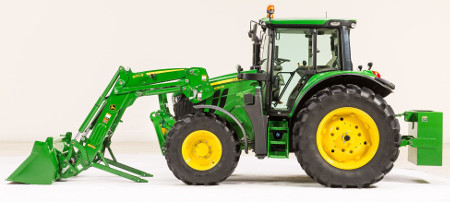 6120M Tractor with 600R Loader
6120M Tractor with 600R Loader
The 600R Loader has been redesigned to work effortlessly with the model year 2020 6110M and 6120M Tractors. In cadence with the sloped hood design of the tractor, the 600R Loader features curved booms, making an ideal tractor-loader combination. This combination also includes a 22.9-cm (9-in.) reduction in overall machine and loader length, improving forward visibility by over 2.1-m (7 ft). Pairing the model year 2020 6110M or 6120M Tractor with the 600R Loader allows visibility directly to the loader attachment, providing more efficient performance with any loader application.
Panoramic roof for increased visibility
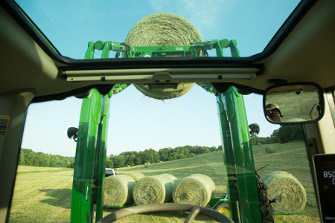 600R Loader through 6120M Tractor panoramic roof
600R Loader through 6120M Tractor panoramic roof
As the lift height of the R-Series Loaders increases, the larger panoramic roof inside the model year 2020 6110M and 6120M Tractor cabs provides additional visibility to the entire lift cycle of the loader. The 600R Loader has a lift height up to 391.2 cm (154 in.), allowing an operator to stack three bales. With the larger panoramic roof, tasks that require maximum loader height can be performed more easily.
Light-emitting diode (LED) light option for variable operating conditions
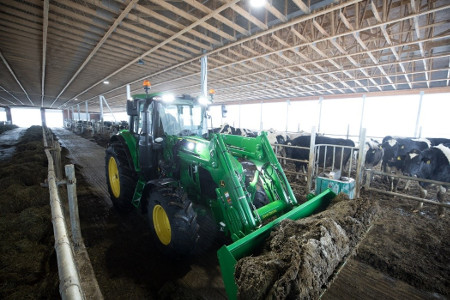 6110M Tractor and 600R Loader with LED light package
6110M Tractor and 600R Loader with LED light package
To further enhance visibility, the model year 2020 6110M/6120M Tractors and 600R Loader have the option to include LED lights. With LED lights emitting from the tractor cab and the loader boom, performing loader applications in variable operating conditions is made easier. Pairing the loader LED light option with an LED light package on the 6110M or 6120M Tractor will provide unmatched visibility to enhance operator experience during any task.
Features
Superior comfort and enhanced operation with cab updates
 6120M standard cab with Compact CommandARM™ console
6120M standard cab with Compact CommandARM™ console
The 6M Tractor was designed to ensure maximum maneuverability, visibility, and superior comfort for operators’ working long days. The 6110M and 6120M, with the updated sloped-down hood design, feature a 17.8-cm (7-in.) shorter wheelbase (240 cm [94.5 in.]) allowing you to maneuver tight areas with no problems. Inside, the 6M cab has been designed to maximize operator comfort and visibility. All-around visibility of 310 degrees from within the cab ensures accurate tractor placement, implement hookup, and optimum tractor performance. Additionally, all 6M Tractors will come standard with a digital cornerpost display and include additional options to further improve operator satisfaction like:
- Mechanical or electrical joystick with PowrReverser™ functionality
- Quickly and easily change directions with the push of a button while doing loader work
- Compact CommandARM console
- Swivel in your seat and have all the controls at your fingertips
- Front axle suspension
- Panoramic roof
 Panoramic roof
Panoramic roof
 Cornerpost display
Cornerpost display
 Compact CommandARM
Compact CommandARM
 PowrReverser
PowrReverser
Boost power and productivity in operations using Intelligent Power Management
 6120M with Intelligent Power Management
6120M with Intelligent Power Management
The 6110M through 6140M Tractors come equipped with Intelligent Power Management (IPM). IPM provides a 14.9-kW (20-hp) boost for operations that use rear power take-off (PTO) in high-power applications or in transport. Benefits of IPM include improved productivity, increased acceleration, and the ability to maintain desired transport speeds. The requirements for IPM to be active include:
- Transport applications: The minimum ground speed where additional power begins to be applied for all models is 15 km/h (9.3 mph), assuming the engine is already fully loaded. Ramp-up to full additional power occurs as speed continues to increase.
- PTO activation: Power must be sensed going through the PTO drive clutch by the electronic system. When using PTO-driven implements, engine power is increased gradually when ground speed exceeds 1 km/h (0.6 mph) if the electronic system detects a correspondingly high PTO power requirement. Full power becomes available from a speed of 2.5 km/h (1.5 mph).
Easy implement control using rear-mounted selective control valves (SCVs)
 Optional electrical control valves (E-SCVs)
Optional electrical control valves (E-SCVs)
All 6M models come with the option to upgrade from mechanical to electronically controlled SCVs. To control a rear implement, up to four electrical SCVs or three electrical SCVs plus power beyond can be ordered. Each SCV features four positions – neutral, raise, lower, and float. The electrical SCVs are fully adjustable with the digital cornerpost display. Additionally, you can choose what SCVs are right for your operation with the following combinations of SCVs:
With Compact CommandARM™ console:
- Up to four electrical SCVs possible or three plus power beyond
- Loader packages with electrical joystick available
- Mechanical SCVs are not available
With right-hand console:
- Up to three mechanical SCVs possible plus power beyond
- Up to four electrical SCVs possible or three plus power beyond
- Combination of two electrical and one or two mechanical SCVs is possible
- Loader packages with maximum of three mechanical SCVs available
- Loader packages with electrical joystick available
Increase versatility with a front hitch and front power take-off (PTO)
 6120M with optional front hitch
6120M with optional front hitch
For all 6M Series Tractors, an optional integrated John Deere Category 3N front hitch with hook-end draft links can be factory installed. The high lift capacity of 4400 kg (9,700 lb) maximum and 3300 kg (7,275 lb) through the full lift range ensures compatibility with heavy front implements and ballasts. If the tractor is not equipped with Triple-Link Suspension (TLS™), an accumulator will be installed to ensure driving comfort. The economy front hitch allows:
- Maximum uptime with quick and easy changing from folded to working position
- The operator to be highly flexible with the front ballast
- Optional availability of integrated front power take-off (PTO)
Increase visibility and productivity with light packages
 6155M with Premium light-emitting diode (LED) light package
6155M with Premium light-emitting diode (LED) light package
Lights on the 6M Series Tractors have been positioned and designed to provide maximum visibility to the front, sides, and rear to increase productivity in any operating conditions. The updated cab lighting pattern provides 330 degrees of coverage while the hood lighting provides the remaining 30 degrees. You have two options to upgrade lighting with the Economy and Premium light packages available:
- Economy light package
- Two additional work lights in the front, side, and rear
- Premium light package
- Two additional work lights in the front, side, and rear
- All lights are LED lights
Both packages require the 14-V/150-amp alternator (code 8741) and 12-V/174-amp-hr battery (code 8747).
Stay connected to all machines from anywhere with JDLink™ system
 John Deere 6155M with StarFire™ 6000 Receiver and tablet with JDLink
John Deere 6155M with StarFire™ 6000 Receiver and tablet with JDLink
JDLink is available from the factory for all 6M Tractors. JDLink is John Deere's telematics system connecting all machines in the field with the office and mobile devices. The technology is based on a Modular Telematics Gateway (MTG) controller that collects and transmits data via cellular network using selective data points in near real-time. Information and features can be accessed through Operations Center, the JDLink tab on MyJohnDeere.com, or by using the JDLink app. JDLink also enables you to:
- Access important machine information like machine hours
- Keep track of your fleets
- Monitor work progress
- Manage logistics
- Analyze and optimize machine performance
- Receive alter SMS or email messages
- Perform remote operator support
- Automate data exchange
You can choose between two subscription levels: JDLink Access and JDLink Connect.
 John Deere 6155M and 835 Mower Conditioner with StarFire 6000 Receiver and JDLink
John Deere 6155M and 835 Mower Conditioner with StarFire 6000 Receiver and JDLink
Improved access for serviceability with side panels and oil dipstick location
 Removable side panels for easy access on 6120M
Removable side panels for easy access on 6120M
 Side panels attached to the 6120M
Side panels attached to the 6120M
6M Series Tractors have been redesigned to meet stringent reliability and serviceability requirements. Daily service requirements have been reduced and are simple to accomplish with improved accessibility to the engine. All 6M models are equipped with a 60-degree hood, and the 6110M and 6120M feature removeable side panels, allowing easy access to reduce time and make serviceability even easier. These features allow you to quickly and easily check parts like:
- Engine oil filter
- Engine fuel filter
- Coolant recovery tank
- Radiator cleanout screens
- Air cleaner
Additionally, the oil dipstick on the 6110M and 6120M allows you to check the engine oil level without opening the hood.
 Updated oil dipstick location on 6110M-6120M
Updated oil dipstick location on 6110M-6120M
Complete tasks quickly and easily with the 4240/4640 Universal Display
 John Deere 4240 Universal Display
John Deere 4240 Universal Display
The latest John Deere display technology offered in a moveable and user-friendly experience is available with the John Deere 4240 and 4640 Universal Displays. These displays enable AutoTrac™ guidance that provides enhanced usability, increased performance, and greater operator choice. Additional benefits include:
- Support flags – document a point, line, or area of a field that needs later attention
- Enhanced data merging functionalities for setup data (no more overwrites)
- AutoTrac guidance improvements – boundary track and preview for guidance lines, tramlines, and machine access
- Keeping the implement on the perfect track even in hilly conditions with AutoTrac Implement Guidance (passive)
Ideal tractor-loader combination with 600R Loader compatibility
Redesigned to improve loader operations
 6120M Tractor with 600R Loader
6120M Tractor with 600R Loader
The 600R Loader has been redesigned to work effortlessly with the model year 2020 6110M and 6120M Tractors. In cadence with the sloped hood design of the tractor, the 600R Loader features curved booms, making an ideal tractor-loader combination. This combination also includes a 22.9-cm (9-in.) reduction in overall machine and loader length, improving forward visibility by over 2.1-m (7 ft). Pairing the model year 2020 6110M or 6120M Tractor with the 600R Loader allows visibility directly to the loader attachment, providing more efficient performance with any loader application.
Panoramic roof for increased visibility
 600R Loader through 6120M Tractor panoramic roof
600R Loader through 6120M Tractor panoramic roof
As the lift height of the R-Series Loaders increases, the larger panoramic roof inside the model year 2020 6110M and 6120M Tractor cabs provides additional visibility to the entire lift cycle of the loader. The 600R Loader has a lift height up to 391.2 cm (154 in.), allowing an operator to stack three bales. With the larger panoramic roof, tasks that require maximum loader height can be performed more easily.
Light-emitting diode (LED) light option for variable operating conditions
 6110M Tractor and 600R Loader with LED light package
6110M Tractor and 600R Loader with LED light package
To further enhance visibility, the model year 2020 6110M/6120M Tractors and 600R Loader have the option to include LED lights. With LED lights emitting from the tractor cab and the loader boom, performing loader applications in variable operating conditions is made easier. Pairing the loader LED light option with an LED light package on the 6110M or 6120M Tractor will provide unmatched visibility to enhance operator experience during any task.
Features
Tire combinations; two-wheel-drive (2WD), mechanical front-wheel drive (MFWD) and rear axle – radial tires
Overview
Front and rear radial tire offerings are available on all models, except for the front tires on the open-operator station (OOS) configurations.
 6E with radial tire offering
6E with radial tire offering
Benefits:
- Better ride quality
- Better wear characteristics
- Less compaction
- More efficient converting more power to the ground
Tire combinations by model
| Codes | 6105E | 6120E | 6135E | |
| Two-wheel drive (2WD) front | ||||
| 6151 | 10.00-16 in. 8PR F2 bias | In base | In base | N/A |
| 2WD rear | ||||
| 5234 | 460/85R38 in. 8PR R1W radial | In base | In base | N/A |
| 5212 | 460/85R34 in. 8PR R1W radial | Optional | Optional | N/A |
| 5221 | 420/85/R38 in. 8PR R1W radial | Optional | Optional | N/A |
| Mechanical front-wheel drive (MFWD) front | ||||
| 6220 | 380/85R24 in. 8PR R1W radial | In base | In base | In base |
| 6210 | 340/85R24 in. 8PR R1W radial | Optional | Optional | Optional |
| MFWD rear | ||||
| 5234 | 460/85R38 in. 8PR R1W radial | In base | In base | In base |
| 5212 | 460/85R34 in. 8PR R1W radial | Optional | Optional | Optional |
| 5221 | 420/85/R38 in. 8PR R1W radial | Optional | Optional | Optional |
Loader-ready packages
Overview:
To further the versatility and efficiency of the 6E Tractors and their hydraulic capabilities, the 6Es can be ordered loader ready. Being able to add a loader to a 6E Tractor makes it an even more capable solution to the various tasks a utility tractor is challenged with.
Mechanical joystick with dual-function mid-mount valve
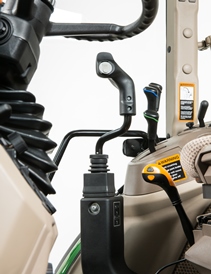 Joystick installed in cab tractor
Joystick installed in cab tractor
Overview:
For the operator wanting to install a loader on a tractor, two-function and three-function hydraulic mid-mount valves with mechanical joystick are available.
Benefits:
The operator will be able to operate the loader using a joystick, increasing productivity and maneuverability
Available for both cab and OOS configurations on all 6Es
Quick installation of a loader once the tractor is received
Improved resale value
NOTE: To field install the single-function lever controls (both two and three function) please refer to the Loader Sales Manual and Price Pages.
Details:
| Code | Description | Availability |
| 8910 | Loader-ready package, two function mid-mount valve with mechanical joystick |
All 6E Series Tractors |
| 8911 | Loader-ready package, three function mid-mount valve with mechanical joystick |
All 6E Series Tractors |
Engine, 4.5L PowerTech™ power and specifications
Tractor models and horsepower
 PowerTech engine
PowerTech engine
Overview:
All John Deere 6E Series Tractors feature the reliable and proven 4.5L (275-cu in.) engines. These engines deliver constant power over a wide range of rpm with a power bulge above rated power and excellent torque characteristics.
The 6E Series, while being value-featured and competitively priced, are built with John Deere's long-standing reputation for reliability, durability, and maintainability.
Model and horsepower outputs
| Model | Displacement, |
Rated power take-off (PTO) hp |
Rated engine hp |
| 6105E | 4.5 (276) | 89 | 105 |
| 6120E | 4.5 (276) | 102 | 120 |
| 6135E | 4.5 (276) | 115 | 135 |
Rated engine horsepower ratings are included for reference to competitor's gross or engine-only power ratings. There are several ratings systems used by other manufacturers. John Deere uses the horsepower-rating standard 97/68/EC, which is widely used in Europe for various regulations.
How is engine-only rated and maximum power determined?
John Deere engineering uses a precise procedure to measure engine-only power levels. The 97/68/EC standard is required in the European Union (EU) as an emission test, so there is some relation to the power a tractor has as a whole functioning unit; however, the procedure requires only that a production engine and radiator are used on a dynamometer test. Use the 97/68/EC horsepower ratings in the above chart to compare to competitor claims of engine-only power.
Benefits:
PTO power and power bulge
The John Deere exclusive single-injector control, electronic fuel injection system, and other key engine parts, work together to sense engine load and instantly respond as needed to pull through tough spots. This reduces engine rpm fluctuation resulting in the reduced need to downshift the transmission. Fewer shifts result in fewer ground variations, providing more overall tractor productivity.
To match the engine power characteristics and improve economy of operation, the rated engine speed is 2200 rpm.
Feature and benefit overview
High-pressure common rail fuel system
- Higher injection pressures, up to 27,500 psi, precise variable injection pressure, variable timing control, multiple injections
Four-valve cylinder head
- Cross-flow head design that provides excellent breathing from a lower-cost four-valve cylinder head
Turbocharged
- In turbocharged engines, the air is pre-compressed. Due to the higher pressure, more air is supplied into the combustion chamber allowing a corresponding increase in fuel injection which results in greater engine output.
Turbochargers
- Precisely matched to the power level and application, the 6Es are equipped with a wastegate (to divert exhaust gases) turbo.
Air-to-air intercooling
- Most efficient method of cooling intake air to help reduce engine emissions while maintaining low speed torque, transient response time and peak torque. Enables the engine to meet emission requirements with better fuel economy and the lowest installed costs.
Compact size
- 4.5 L (276 cu in.) 4-cylinder.
Engine performance
- Power bulge feature
- Increased low-speed torque
- Multiple rated speeds to further reduce noise and improve fuel economy
- Higher peak torque ratings
- Faster torque rise
John Deere electronic engine controls
Monitors critical engine functions providing warning and/or shutdown to prevent costly engine repairs; eliminates need for add-on governing components; all lowering total installed costs.
Snapshot diagnostic data that can be retrieved using commonly available diagnostic service tools
New common wiring interface connector for vehicles or available OEM instrumentation packages; new solid conduit and T-connectors to reduce wiring stress, greater durability and improved appearance
Factory-installed engine-mounted ECU, wiring harness and associated components; industry standard SAE J1939 interface which communicates with other vehicle systems, eliminating redundant sensors and reducing vehicle total installed cost.
Additional features
- Self-adjusting poly-v-fan drive
- Forged-steel connecting rods
- Replaceable wet-type cylinder liners
- 500-hour oil change
Details:
Engine performance
| Model | 6105E | 6120E | 6135E |
| EPA tier level | FT4 | FT4 | FT4 |
| Engine model | 4045H | 4045H | 4045H |
| 97/68/EC at rated speed kW (hp) | 77 (105) | 88 (120) | 99 (135) |
| Rated engine speed (rpm) | 2200 | 2200 | 2200 |
| PTO operating speed (rpm) | 2100 | 2100 | 2100 |
| Maximum torque engine speed (rpm) | 1600 | 1600 | 1600 |
| Fast idle speed (rpm) | 2275+10 | 2275+10 | 2275+10 |
| Low idle speed (rpm) | 900+10 | 900+10 | 900+10 |
Torque curves
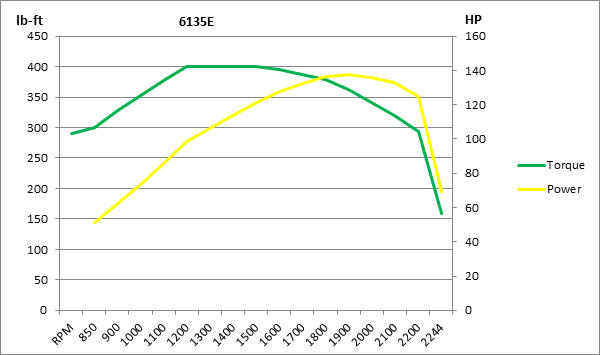 6135E torque curves graph
6135E torque curves graph
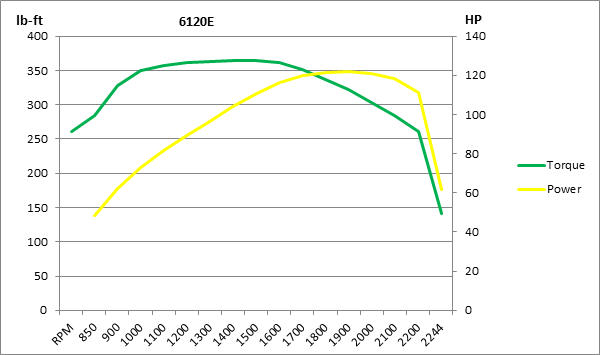 6120E torque curves graph
6120E torque curves graph
 6105E torque curves graph
6105E torque curves graph
Service intervals
John Deere engines are designed and manufactured to deliver excellent reliability. The recommended service intervals of the engine should be coordinated with the tractor service intervals.
| Engine break-in service | 500 hours maximum with factory ship away oil and filter change |
| Engine oil & filter change | 250 hours – oil and filter change |
| Engine oil filter change | With oil change |
| Engine fuel filter change | As required, 500 hours, or yearly |
| Drain water separator | Check and drain daily or every 10 hours |
| Engine coolant change | 5 years or 5000 hours with John Deere COOL-GARD™ II and annual coolant tests |
| Engine coolant conditioner | As required every 500 hours |
| Diesel particulate filter (DPF) cleaning interval | As required |
| DPF and diesel oxidation catalyst (DOC) replacement | As required |
Open crankcase ventilation (OCV) |
1500 hours |
| Diesel exhaust fluid (DEF) filter replacement | Every 3 years or 4500 hours |
Engine specifications
| Model | 6105E | 6120E | 6135E |
| Engine | PowerTech PWL | PowerTech PWL | PowerTech PWS |
| Engine model | 4045H | 4045H | 4045H |
| Size | 4.5 L (276 cu in.) |
4.5 L (276 cu in.) | 4.5 L (276 cu in.) |
| No. cylinders | 4 | 4 | 4 |
| Valves per cylinder | 4 | 4 | 4 |
| Aspiration | Turbo and aftercooled | Turbo and aftercooled | Turbo and aftercooled |
| Engine management | Electronic | Electronic | Electronic |
| Fuel delivery | High-pressure common rail (HPCR) | HPCR | HPCR |
| Rated engine speed, rpm | 2200 | 2200 | 2200 |
| PTO operating speed, rpm | 2100 | 2100 | 2100 |
| Maximum torque operating speed, rpm | 1600 | 1600 | 1600 |
| Fast idle speed, rpm | 2275 | 2275 | 2275 |
| Low idle speed, rpm | 900 | 900 | 900 |
| Rated PTO power | 89 PTO horsepower |
102 PTO horsepower |
115 PTO horsepower |
| Rated engine power | 105 hp at 2200 rpm [97/68/EC] | 120 hp at 2200 rpm [97/68/EC] | 135 hp at 2200 rpm [97/68/EC] |
| Power bulge | 3% at 2000 rpm | 3% at 2000 rpm | 3% at 2000 rpm |
| Peak torque | 318 lb-ft (432 N.m.) at 1600 rpm | 364 lb-ft (494 N.m.) at 1600 rpm | 397 lb-ft (539 N.m.) at 1600 rpm |
| Torque rise | 29% at 2200 | 29% at 2200 | 25% at 2200 |
| Compression | 16.8:1 | 16.8:1 | 16.8:1 |
| Bore x stroke | 4.7 x 5.0 in. | 4.7 x 5.0 in. | 4.7 x 5.0 in. |
12 forward/12 reverse (12F/12R) and 24F/12R, PowrReverser™ transmission
Overview:
The 6E Series PowrReverser transmissions deliver unmatched performance. This transmission is ideal for working in tight areas where forward to reverse shifting is a primary occurrence such as in barns, feedlots and loader applications.
Customers who are operating power take-off (PTO) implements like a rotary cutter or baler will appreciate the additional working speeds with the 24F/12R speeds PowrReverser transmission. High and low buttons are used to make fine adjustments in speed without the need to use the clutch delivering improved productivity.
The PowrReverser transmission is base equipment providing 12F/12R speeds. Six well-spaced ground speeds place the operator in the important haying or rotary cutter range of 8 km/h to 20.9 km/h (5 mph to 13 mph). With this transmission, the operator can reach a top speed of 31.5 km/h (19.6 mph). The optional PowrReverser transmission 24F/12R will deliver 11 well-spaced ground speeds to match the correct speed for a haying or rotary cutter application with a top speed of 40 km/h (25 mph).
A dash-mounted PowrReverser modulation kit (LVB25727) is available to set the aggressiveness of the forward and reverse shuttle modulation that best fits the application or the operator's comfort level.
Operator controls
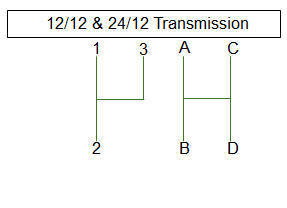 24F/12R high/low buttons
24F/12R high/low buttons
 24F/12R high/low buttons
24F/12R high/low buttons
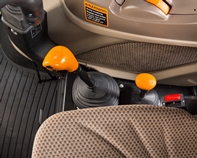 Gear and range levers in cab
Gear and range levers in cab
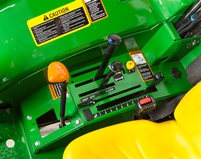 Gear lever in open operator station (OOS)
Gear lever in open operator station (OOS)
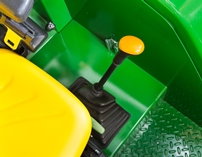 Range lever in OOS
Range lever in OOS
Two levers, one for speed and one for range, with the addition of an electrohydraulic left-hand reverser, provide operators optimum control and maneuverability.
- Range lever (right-hand side [cab], left-hand side [OOS]) selects four ranges (A, B, C, D).
- Gear selection (right-hand side) selects speeds (1, 2, or 3) in the forward or reverse direction.
- Electrohydraulic left-hand reverser allows for quick and convenient shuttle shifting between forward and reverse at any speed.
- High and low buttons are located on the gear shifter for the 24F/12R PowrReverser transmission.
Benefits:
Forward and reverse speeds
All speed gears (1, 2, 3) are fully synchronized for shifting-on-the-go capabilities, putting less wear on the operator and saving time in the field. In the 12F/12R PowrReverser transmission, gears are synchronized for low shifting effort while the operator is doing field or loader work and during transport.
The high and low speeds on the 24F/12R PowrReverser transmission can be shifted without clutching while the tractor is under load. This makes for quick speed changes when operating a rotary cutter or baler.
To further enhance awareness of reverse tractor motion, a backup alarm can be field-installed (BSJ10026).
The ranges (A, B) are not synchronized. This means the tractor must be stopped for the operator to select the range. However, with operator input, the speeds have been well spaced out to minimize the need to change ranges within applications. The ranges (B to C, C to D, and D to C) are synchronized. That allows the operator to shift ranges on the go in transport and high speed applications like operating a mower-conditioner.
Wet clutch
John Deere has led the industry in the innovation of wet clutches. In this wet-clutch design, five 17-cm (6.7-in.) diameter clutch disks provide optimum clutch modulation for smooth operation; the disks are oil-cooled for a lifetime of service.
The biggest advantage of a wet clutch is its ease of use as the required force to depress the pedal is minimal. Also, with a wet clutch, the need for frequent adjustment and clutch mechanism changeover is eliminated.
Details:
Ground speed chart 12F/12R and 24F/12R
| Code | Description | Information | 6105E | 6120E | 6135E |
| 1382 | 12F/12R PowrReverser wet-clutch transmission, two-wheel drive (2WD) front axle |
In base price for 2WD configurations | X | X | |
| 1383 | 12F/12R PowrReverser wet-clutch transmission, mechanical front-wheel drive (MFWD) axle | In base price | X | X | X |
| 1386 | 24F/12R PowrReverser wet-clutch transmission, MFWD axle | Option | X | X | X |
ISOBUS and tractor-baler automation offer new baling experience
Tractor-Baler Automation simplifies baling experience
 A single manual action; system manages the rest
A single manual action; system manages the rest
 TBA awards
TBA awards
The optional Tractor-Baler Automation (TBA) makes baling easy. This exclusive system manages most of the baling process and gives the customer the following advantages:
- High baling comfort a single action to bale instead of four.
- Error proof baling - even after 10 working hours, the system does not forget any action; a true advantage for an inexperienced driver.
- Constant bale quality - same diameter bale after bale
- Constant productivity - no reduced efficiency due to operators fatigue.
When used with a John Deere ISOBUS tractor, electric selective control valve (E-SCV), and (IVT™) transmission, the system will be able to:
- Stop the tractor when bale size is reached
- Wrap the bale
- Open the gate
- Close the gate when bale is unloaded
The only action remaining is to forward reverser and manage the steering.
If the John Deere tractor is not equipped with IVT but has E-SCV and ISOBUS, opening and closing can be automated.
A single touch on SCV, brakes, or reverser will disengage the automation. In the same way, automated open/close can be momentarily stopped when unloading in hilly conditions.
Tractor-Implement Automation is an exclusive green on green advantage. This advanced technology option has won awards at SIMA and Agritechnica farm equipment show in Europe, a true cost/value guarantee.
NOTE: to run through fully automated mode, a John Deere Isobus tractor with E-SCV and IVT is required. A baler activation key and a tractor activation key (different) have to be ordered.
ISOBUS certified balers
 Plug in and bale with ISOBUS
Plug in and bale with ISOBUS
 ISOBUS certified = compatibility guarantee
ISOBUS certified = compatibility guarantee
The 990 and 960 Balers offer ISOBUS compatibility as base equipment. This standardized communication not only allows the use of John Deere Greenstar2 1800, 2600, or 2630 Displays, but also the use of other ISOBUS conform competitive monitors.
Adapter harnesses for non-ISOBUS tractors are available.
User friendly interface
 Main page with simple and clear pictograms
Main page with simple and clear pictograms
 Bale or soft core density adjustments
Bale or soft core density adjustments
The Baler interface displays information that is needed. The 900 Series monitors provide all required information:
- Bale shape and diameter
- Drop floor and knives position
- Variable core activation
- Tying process status
- Gate position
- Maintenance status
Adjustments can also be managed from the operators station:
- Bale size and density
- Variable core diameter and density
- Net and twine tying parameters
- Knife selection
- Automated lubrication
- Tractor-Baler Automation status
- Bale counter resets
Greenstar™2 1800 has the ideal display for baling application
 Greenstar2 1800 Display ordered with the baler
Greenstar2 1800 Display ordered with the baler

The 900 Series Balers can be teamed with all ISOBUS certified displays. The Greenstar2 1800 monitor can be ordered with the baler to match traditional baling requirements. When not baling this display can be used for other functions such as guidance and spraying applications when connected to an appropriate receiver and implement.
All ISOBUS display will fit the 900 Series
 GreenStar3 2630 fits the most demanding user needs
GreenStar3 2630 fits the most demanding user needs

The 960 and 990 Balers can be ordered without a monitor for customers who already have an ISOBUS display, or for those who search more advanced application (field management). Displays other than John Deere Greenstar2 1800 can be purchased through Ag Management Solutions (AMS) pages.
Features
Tire combinations; two-wheel-drive (2WD), mechanical front-wheel drive (MFWD) and rear axle – radial tires
Overview
Front and rear radial tire offerings are available on all models, except for the front tires on the open-operator station (OOS) configurations.
 6E with radial tire offering
6E with radial tire offering
Benefits:
- Better ride quality
- Better wear characteristics
- Less compaction
- More efficient converting more power to the ground
Tire combinations by model
| Codes | 6105E | 6120E | 6135E | |
| Two-wheel drive (2WD) front | ||||
| 6151 | 10.00-16 in. 8PR F2 bias | In base | In base | N/A |
| 2WD rear | ||||
| 5234 | 460/85R38 in. 8PR R1W radial | In base | In base | N/A |
| 5212 | 460/85R34 in. 8PR R1W radial | Optional | Optional | N/A |
| 5221 | 420/85/R38 in. 8PR R1W radial | Optional | Optional | N/A |
| Mechanical front-wheel drive (MFWD) front | ||||
| 6220 | 380/85R24 in. 8PR R1W radial | In base | In base | In base |
| 6210 | 340/85R24 in. 8PR R1W radial | Optional | Optional | Optional |
| MFWD rear | ||||
| 5234 | 460/85R38 in. 8PR R1W radial | In base | In base | In base |
| 5212 | 460/85R34 in. 8PR R1W radial | Optional | Optional | Optional |
| 5221 | 420/85/R38 in. 8PR R1W radial | Optional | Optional | Optional |
Loader-ready packages
Overview:
To further the versatility and efficiency of the 6E Tractors and their hydraulic capabilities, the 6Es can be ordered loader ready. Being able to add a loader to a 6E Tractor makes it an even more capable solution to the various tasks a utility tractor is challenged with.
Mechanical joystick with dual-function mid-mount valve
 Joystick installed in cab tractor
Joystick installed in cab tractor
Overview:
For the operator wanting to install a loader on a tractor, two-function and three-function hydraulic mid-mount valves with mechanical joystick are available.
Benefits:
The operator will be able to operate the loader using a joystick, increasing productivity and maneuverability
Available for both cab and OOS configurations on all 6Es
Quick installation of a loader once the tractor is received
Improved resale value
NOTE: To field install the single-function lever controls (both two and three function) please refer to the Loader Sales Manual and Price Pages.
Details:
| Code | Description | Availability |
| 8910 | Loader-ready package, two function mid-mount valve with mechanical joystick |
All 6E Series Tractors |
| 8911 | Loader-ready package, three function mid-mount valve with mechanical joystick |
All 6E Series Tractors |
Engine, 4.5L PowerTech™ power and specifications
Tractor models and horsepower
 PowerTech engine
PowerTech engine
Overview:
All John Deere 6E Series Tractors feature the reliable and proven 4.5L (275-cu in.) engines. These engines deliver constant power over a wide range of rpm with a power bulge above rated power and excellent torque characteristics.
The 6E Series, while being value-featured and competitively priced, are built with John Deere's long-standing reputation for reliability, durability, and maintainability.
Model and horsepower outputs
| Model | Displacement, |
Rated power take-off (PTO) hp |
Rated engine hp |
| 6105E | 4.5 (276) | 89 | 105 |
| 6120E | 4.5 (276) | 102 | 120 |
| 6135E | 4.5 (276) | 115 | 135 |
Rated engine horsepower ratings are included for reference to competitor's gross or engine-only power ratings. There are several ratings systems used by other manufacturers. John Deere uses the horsepower-rating standard 97/68/EC, which is widely used in Europe for various regulations.
How is engine-only rated and maximum power determined?
John Deere engineering uses a precise procedure to measure engine-only power levels. The 97/68/EC standard is required in the European Union (EU) as an emission test, so there is some relation to the power a tractor has as a whole functioning unit; however, the procedure requires only that a production engine and radiator are used on a dynamometer test. Use the 97/68/EC horsepower ratings in the above chart to compare to competitor claims of engine-only power.
Benefits:
PTO power and power bulge
The John Deere exclusive single-injector control, electronic fuel injection system, and other key engine parts, work together to sense engine load and instantly respond as needed to pull through tough spots. This reduces engine rpm fluctuation resulting in the reduced need to downshift the transmission. Fewer shifts result in fewer ground variations, providing more overall tractor productivity.
To match the engine power characteristics and improve economy of operation, the rated engine speed is 2200 rpm.
Feature and benefit overview
High-pressure common rail fuel system
- Higher injection pressures, up to 27,500 psi, precise variable injection pressure, variable timing control, multiple injections
Four-valve cylinder head
- Cross-flow head design that provides excellent breathing from a lower-cost four-valve cylinder head
Turbocharged
- In turbocharged engines, the air is pre-compressed. Due to the higher pressure, more air is supplied into the combustion chamber allowing a corresponding increase in fuel injection which results in greater engine output.
Turbochargers
- Precisely matched to the power level and application, the 6Es are equipped with a wastegate (to divert exhaust gases) turbo.
Air-to-air intercooling
- Most efficient method of cooling intake air to help reduce engine emissions while maintaining low speed torque, transient response time and peak torque. Enables the engine to meet emission requirements with better fuel economy and the lowest installed costs.
Compact size
- 4.5 L (276 cu in.) 4-cylinder.
Engine performance
- Power bulge feature
- Increased low-speed torque
- Multiple rated speeds to further reduce noise and improve fuel economy
- Higher peak torque ratings
- Faster torque rise
John Deere electronic engine controls
Monitors critical engine functions providing warning and/or shutdown to prevent costly engine repairs; eliminates need for add-on governing components; all lowering total installed costs.
Snapshot diagnostic data that can be retrieved using commonly available diagnostic service tools
New common wiring interface connector for vehicles or available OEM instrumentation packages; new solid conduit and T-connectors to reduce wiring stress, greater durability and improved appearance
Factory-installed engine-mounted ECU, wiring harness and associated components; industry standard SAE J1939 interface which communicates with other vehicle systems, eliminating redundant sensors and reducing vehicle total installed cost.
Additional features
- Self-adjusting poly-v-fan drive
- Forged-steel connecting rods
- Replaceable wet-type cylinder liners
- 500-hour oil change
Details:
Engine performance
| Model | 6105E | 6120E | 6135E |
| EPA tier level | FT4 | FT4 | FT4 |
| Engine model | 4045H | 4045H | 4045H |
| 97/68/EC at rated speed kW (hp) | 77 (105) | 88 (120) | 99 (135) |
| Rated engine speed (rpm) | 2200 | 2200 | 2200 |
| PTO operating speed (rpm) | 2100 | 2100 | 2100 |
| Maximum torque engine speed (rpm) | 1600 | 1600 | 1600 |
| Fast idle speed (rpm) | 2275+10 | 2275+10 | 2275+10 |
| Low idle speed (rpm) | 900+10 | 900+10 | 900+10 |
Torque curves
 6135E torque curves graph
6135E torque curves graph
 6120E torque curves graph
6120E torque curves graph
 6105E torque curves graph
6105E torque curves graph
Service intervals
John Deere engines are designed and manufactured to deliver excellent reliability. The recommended service intervals of the engine should be coordinated with the tractor service intervals.
| Engine break-in service | 500 hours maximum with factory ship away oil and filter change |
| Engine oil & filter change | 250 hours – oil and filter change |
| Engine oil filter change | With oil change |
| Engine fuel filter change | As required, 500 hours, or yearly |
| Drain water separator | Check and drain daily or every 10 hours |
| Engine coolant change | 5 years or 5000 hours with John Deere COOL-GARD™ II and annual coolant tests |
| Engine coolant conditioner | As required every 500 hours |
| Diesel particulate filter (DPF) cleaning interval | As required |
| DPF and diesel oxidation catalyst (DOC) replacement | As required |
Open crankcase ventilation (OCV) |
1500 hours |
| Diesel exhaust fluid (DEF) filter replacement | Every 3 years or 4500 hours |
Engine specifications
| Model | 6105E | 6120E | 6135E |
| Engine | PowerTech PWL | PowerTech PWL | PowerTech PWS |
| Engine model | 4045H | 4045H | 4045H |
| Size | 4.5 L (276 cu in.) |
4.5 L (276 cu in.) | 4.5 L (276 cu in.) |
| No. cylinders | 4 | 4 | 4 |
| Valves per cylinder | 4 | 4 | 4 |
| Aspiration | Turbo and aftercooled | Turbo and aftercooled | Turbo and aftercooled |
| Engine management | Electronic | Electronic | Electronic |
| Fuel delivery | High-pressure common rail (HPCR) | HPCR | HPCR |
| Rated engine speed, rpm | 2200 | 2200 | 2200 |
| PTO operating speed, rpm | 2100 | 2100 | 2100 |
| Maximum torque operating speed, rpm | 1600 | 1600 | 1600 |
| Fast idle speed, rpm | 2275 | 2275 | 2275 |
| Low idle speed, rpm | 900 | 900 | 900 |
| Rated PTO power | 89 PTO horsepower |
102 PTO horsepower |
115 PTO horsepower |
| Rated engine power | 105 hp at 2200 rpm [97/68/EC] | 120 hp at 2200 rpm [97/68/EC] | 135 hp at 2200 rpm [97/68/EC] |
| Power bulge | 3% at 2000 rpm | 3% at 2000 rpm | 3% at 2000 rpm |
| Peak torque | 318 lb-ft (432 N.m.) at 1600 rpm | 364 lb-ft (494 N.m.) at 1600 rpm | 397 lb-ft (539 N.m.) at 1600 rpm |
| Torque rise | 29% at 2200 | 29% at 2200 | 25% at 2200 |
| Compression | 16.8:1 | 16.8:1 | 16.8:1 |
| Bore x stroke | 4.7 x 5.0 in. | 4.7 x 5.0 in. | 4.7 x 5.0 in. |
12 forward/12 reverse (12F/12R) and 24F/12R, PowrReverser™ transmission
Overview:
The 6E Series PowrReverser transmissions deliver unmatched performance. This transmission is ideal for working in tight areas where forward to reverse shifting is a primary occurrence such as in barns, feedlots and loader applications.
Customers who are operating power take-off (PTO) implements like a rotary cutter or baler will appreciate the additional working speeds with the 24F/12R speeds PowrReverser transmission. High and low buttons are used to make fine adjustments in speed without the need to use the clutch delivering improved productivity.
The PowrReverser transmission is base equipment providing 12F/12R speeds. Six well-spaced ground speeds place the operator in the important haying or rotary cutter range of 8 km/h to 20.9 km/h (5 mph to 13 mph). With this transmission, the operator can reach a top speed of 31.5 km/h (19.6 mph). The optional PowrReverser transmission 24F/12R will deliver 11 well-spaced ground speeds to match the correct speed for a haying or rotary cutter application with a top speed of 40 km/h (25 mph).
A dash-mounted PowrReverser modulation kit (LVB25727) is available to set the aggressiveness of the forward and reverse shuttle modulation that best fits the application or the operator's comfort level.
Operator controls
 24F/12R high/low buttons
24F/12R high/low buttons
 24F/12R high/low buttons
24F/12R high/low buttons
 Gear and range levers in cab
Gear and range levers in cab
 Gear lever in open operator station (OOS)
Gear lever in open operator station (OOS)
 Range lever in OOS
Range lever in OOS
Two levers, one for speed and one for range, with the addition of an electrohydraulic left-hand reverser, provide operators optimum control and maneuverability.
- Range lever (right-hand side [cab], left-hand side [OOS]) selects four ranges (A, B, C, D).
- Gear selection (right-hand side) selects speeds (1, 2, or 3) in the forward or reverse direction.
- Electrohydraulic left-hand reverser allows for quick and convenient shuttle shifting between forward and reverse at any speed.
- High and low buttons are located on the gear shifter for the 24F/12R PowrReverser transmission.
Benefits:
Forward and reverse speeds
All speed gears (1, 2, 3) are fully synchronized for shifting-on-the-go capabilities, putting less wear on the operator and saving time in the field. In the 12F/12R PowrReverser transmission, gears are synchronized for low shifting effort while the operator is doing field or loader work and during transport.
The high and low speeds on the 24F/12R PowrReverser transmission can be shifted without clutching while the tractor is under load. This makes for quick speed changes when operating a rotary cutter or baler.
To further enhance awareness of reverse tractor motion, a backup alarm can be field-installed (BSJ10026).
The ranges (A, B) are not synchronized. This means the tractor must be stopped for the operator to select the range. However, with operator input, the speeds have been well spaced out to minimize the need to change ranges within applications. The ranges (B to C, C to D, and D to C) are synchronized. That allows the operator to shift ranges on the go in transport and high speed applications like operating a mower-conditioner.
Wet clutch
John Deere has led the industry in the innovation of wet clutches. In this wet-clutch design, five 17-cm (6.7-in.) diameter clutch disks provide optimum clutch modulation for smooth operation; the disks are oil-cooled for a lifetime of service.
The biggest advantage of a wet clutch is its ease of use as the required force to depress the pedal is minimal. Also, with a wet clutch, the need for frequent adjustment and clutch mechanism changeover is eliminated.
Details:
Ground speed chart 12F/12R and 24F/12R
| Code | Description | Information | 6105E | 6120E | 6135E |
| 1382 | 12F/12R PowrReverser wet-clutch transmission, two-wheel drive (2WD) front axle |
In base price for 2WD configurations | X | X | |
| 1383 | 12F/12R PowrReverser wet-clutch transmission, mechanical front-wheel drive (MFWD) axle | In base price | X | X | X |
| 1386 | 24F/12R PowrReverser wet-clutch transmission, MFWD axle | Option | X | X | X |
ISOBUS and tractor-baler automation offer new baling experience
Tractor-Baler Automation simplifies baling experience
 A single manual action; system manages the rest
A single manual action; system manages the rest
 TBA awards
TBA awards
The optional Tractor-Baler Automation (TBA) makes baling easy. This exclusive system manages most of the baling process and gives the customer the following advantages:
- High baling comfort a single action to bale instead of four.
- Error proof baling - even after 10 working hours, the system does not forget any action; a true advantage for an inexperienced driver.
- Constant bale quality - same diameter bale after bale
- Constant productivity - no reduced efficiency due to operators fatigue.
When used with a John Deere ISOBUS tractor, electric selective control valve (E-SCV), and (IVT™) transmission, the system will be able to:
- Stop the tractor when bale size is reached
- Wrap the bale
- Open the gate
- Close the gate when bale is unloaded
The only action remaining is to forward reverser and manage the steering.
If the John Deere tractor is not equipped with IVT but has E-SCV and ISOBUS, opening and closing can be automated.
A single touch on SCV, brakes, or reverser will disengage the automation. In the same way, automated open/close can be momentarily stopped when unloading in hilly conditions.
Tractor-Implement Automation is an exclusive green on green advantage. This advanced technology option has won awards at SIMA and Agritechnica farm equipment show in Europe, a true cost/value guarantee.
NOTE: to run through fully automated mode, a John Deere Isobus tractor with E-SCV and IVT is required. A baler activation key and a tractor activation key (different) have to be ordered.
ISOBUS certified balers
 Plug in and bale with ISOBUS
Plug in and bale with ISOBUS
 ISOBUS certified = compatibility guarantee
ISOBUS certified = compatibility guarantee
The 990 and 960 Balers offer ISOBUS compatibility as base equipment. This standardized communication not only allows the use of John Deere Greenstar2 1800, 2600, or 2630 Displays, but also the use of other ISOBUS conform competitive monitors.
Adapter harnesses for non-ISOBUS tractors are available.
User friendly interface
 Main page with simple and clear pictograms
Main page with simple and clear pictograms
 Bale or soft core density adjustments
Bale or soft core density adjustments
The Baler interface displays information that is needed. The 900 Series monitors provide all required information:
- Bale shape and diameter
- Drop floor and knives position
- Variable core activation
- Tying process status
- Gate position
- Maintenance status
Adjustments can also be managed from the operators station:
- Bale size and density
- Variable core diameter and density
- Net and twine tying parameters
- Knife selection
- Automated lubrication
- Tractor-Baler Automation status
- Bale counter resets
Greenstar™2 1800 has the ideal display for baling application
 Greenstar2 1800 Display ordered with the baler
Greenstar2 1800 Display ordered with the baler

The 900 Series Balers can be teamed with all ISOBUS certified displays. The Greenstar2 1800 monitor can be ordered with the baler to match traditional baling requirements. When not baling this display can be used for other functions such as guidance and spraying applications when connected to an appropriate receiver and implement.
All ISOBUS display will fit the 900 Series
 GreenStar3 2630 fits the most demanding user needs
GreenStar3 2630 fits the most demanding user needs

The 960 and 990 Balers can be ordered without a monitor for customers who already have an ISOBUS display, or for those who search more advanced application (field management). Displays other than John Deere Greenstar2 1800 can be purchased through Ag Management Solutions (AMS) pages.
Features
Tire combinations; two-wheel-drive (2WD), mechanical front-wheel drive (MFWD) and rear axle – radial tires
Overview
Front and rear radial tire offerings are available on all models, except for the front tires on the open-operator station (OOS) configurations.
 6E with radial tire offering
6E with radial tire offering
Benefits:
- Better ride quality
- Better wear characteristics
- Less compaction
- More efficient converting more power to the ground
Tire combinations by model
| Codes | 6105E | 6120E | 6135E | |
| Two-wheel drive (2WD) front | ||||
| 6151 | 10.00-16 in. 8PR F2 bias | In base | In base | N/A |
| 2WD rear | ||||
| 5234 | 460/85R38 in. 8PR R1W radial | In base | In base | N/A |
| 5212 | 460/85R34 in. 8PR R1W radial | Optional | Optional | N/A |
| 5221 | 420/85/R38 in. 8PR R1W radial | Optional | Optional | N/A |
| Mechanical front-wheel drive (MFWD) front | ||||
| 6220 | 380/85R24 in. 8PR R1W radial | In base | In base | In base |
| 6210 | 340/85R24 in. 8PR R1W radial | Optional | Optional | Optional |
| MFWD rear | ||||
| 5234 | 460/85R38 in. 8PR R1W radial | In base | In base | In base |
| 5212 | 460/85R34 in. 8PR R1W radial | Optional | Optional | Optional |
| 5221 | 420/85/R38 in. 8PR R1W radial | Optional | Optional | Optional |
Loader-ready packages
Overview:
To further the versatility and efficiency of the 6E Tractors and their hydraulic capabilities, the 6Es can be ordered loader ready. Being able to add a loader to a 6E Tractor makes it an even more capable solution to the various tasks a utility tractor is challenged with.
Mechanical joystick with dual-function mid-mount valve
 Joystick installed in cab tractor
Joystick installed in cab tractor
Overview:
For the operator wanting to install a loader on a tractor, two-function and three-function hydraulic mid-mount valves with mechanical joystick are available.
Benefits:
The operator will be able to operate the loader using a joystick, increasing productivity and maneuverability
Available for both cab and OOS configurations on all 6Es
Quick installation of a loader once the tractor is received
Improved resale value
NOTE: To field install the single-function lever controls (both two and three function) please refer to the Loader Sales Manual and Price Pages.
Details:
| Code | Description | Availability |
| 8910 | Loader-ready package, two function mid-mount valve with mechanical joystick |
All 6E Series Tractors |
| 8911 | Loader-ready package, three function mid-mount valve with mechanical joystick |
All 6E Series Tractors |
Engine, 4.5L PowerTech™ power and specifications
Tractor models and horsepower
 PowerTech engine
PowerTech engine
Overview:
All John Deere 6E Series Tractors feature the reliable and proven 4.5L (275-cu in.) engines. These engines deliver constant power over a wide range of rpm with a power bulge above rated power and excellent torque characteristics.
The 6E Series, while being value-featured and competitively priced, are built with John Deere's long-standing reputation for reliability, durability, and maintainability.
Model and horsepower outputs
| Model | Displacement, |
Rated power take-off (PTO) hp |
Rated engine hp |
| 6105E | 4.5 (276) | 89 | 105 |
| 6120E | 4.5 (276) | 102 | 120 |
| 6135E | 4.5 (276) | 115 | 135 |
Rated engine horsepower ratings are included for reference to competitor's gross or engine-only power ratings. There are several ratings systems used by other manufacturers. John Deere uses the horsepower-rating standard 97/68/EC, which is widely used in Europe for various regulations.
How is engine-only rated and maximum power determined?
John Deere engineering uses a precise procedure to measure engine-only power levels. The 97/68/EC standard is required in the European Union (EU) as an emission test, so there is some relation to the power a tractor has as a whole functioning unit; however, the procedure requires only that a production engine and radiator are used on a dynamometer test. Use the 97/68/EC horsepower ratings in the above chart to compare to competitor claims of engine-only power.
Benefits:
PTO power and power bulge
The John Deere exclusive single-injector control, electronic fuel injection system, and other key engine parts, work together to sense engine load and instantly respond as needed to pull through tough spots. This reduces engine rpm fluctuation resulting in the reduced need to downshift the transmission. Fewer shifts result in fewer ground variations, providing more overall tractor productivity.
To match the engine power characteristics and improve economy of operation, the rated engine speed is 2200 rpm.
Feature and benefit overview
High-pressure common rail fuel system
- Higher injection pressures, up to 27,500 psi, precise variable injection pressure, variable timing control, multiple injections
Four-valve cylinder head
- Cross-flow head design that provides excellent breathing from a lower-cost four-valve cylinder head
Turbocharged
- In turbocharged engines, the air is pre-compressed. Due to the higher pressure, more air is supplied into the combustion chamber allowing a corresponding increase in fuel injection which results in greater engine output.
Turbochargers
- Precisely matched to the power level and application, the 6Es are equipped with a wastegate (to divert exhaust gases) turbo.
Air-to-air intercooling
- Most efficient method of cooling intake air to help reduce engine emissions while maintaining low speed torque, transient response time and peak torque. Enables the engine to meet emission requirements with better fuel economy and the lowest installed costs.
Compact size
- 4.5 L (276 cu in.) 4-cylinder.
Engine performance
- Power bulge feature
- Increased low-speed torque
- Multiple rated speeds to further reduce noise and improve fuel economy
- Higher peak torque ratings
- Faster torque rise
John Deere electronic engine controls
Monitors critical engine functions providing warning and/or shutdown to prevent costly engine repairs; eliminates need for add-on governing components; all lowering total installed costs.
Snapshot diagnostic data that can be retrieved using commonly available diagnostic service tools
New common wiring interface connector for vehicles or available OEM instrumentation packages; new solid conduit and T-connectors to reduce wiring stress, greater durability and improved appearance
Factory-installed engine-mounted ECU, wiring harness and associated components; industry standard SAE J1939 interface which communicates with other vehicle systems, eliminating redundant sensors and reducing vehicle total installed cost.
Additional features
- Self-adjusting poly-v-fan drive
- Forged-steel connecting rods
- Replaceable wet-type cylinder liners
- 500-hour oil change
Details:
Engine performance
| Model | 6105E | 6120E | 6135E |
| EPA tier level | FT4 | FT4 | FT4 |
| Engine model | 4045H | 4045H | 4045H |
| 97/68/EC at rated speed kW (hp) | 77 (105) | 88 (120) | 99 (135) |
| Rated engine speed (rpm) | 2200 | 2200 | 2200 |
| PTO operating speed (rpm) | 2100 | 2100 | 2100 |
| Maximum torque engine speed (rpm) | 1600 | 1600 | 1600 |
| Fast idle speed (rpm) | 2275+10 | 2275+10 | 2275+10 |
| Low idle speed (rpm) | 900+10 | 900+10 | 900+10 |
Torque curves
 6135E torque curves graph
6135E torque curves graph
 6120E torque curves graph
6120E torque curves graph
 6105E torque curves graph
6105E torque curves graph
Service intervals
John Deere engines are designed and manufactured to deliver excellent reliability. The recommended service intervals of the engine should be coordinated with the tractor service intervals.
| Engine break-in service | 500 hours maximum with factory ship away oil and filter change |
| Engine oil & filter change | 250 hours – oil and filter change |
| Engine oil filter change | With oil change |
| Engine fuel filter change | As required, 500 hours, or yearly |
| Drain water separator | Check and drain daily or every 10 hours |
| Engine coolant change | 5 years or 5000 hours with John Deere COOL-GARD™ II and annual coolant tests |
| Engine coolant conditioner | As required every 500 hours |
| Diesel particulate filter (DPF) cleaning interval | As required |
| DPF and diesel oxidation catalyst (DOC) replacement | As required |
Open crankcase ventilation (OCV) |
1500 hours |
| Diesel exhaust fluid (DEF) filter replacement | Every 3 years or 4500 hours |
Engine specifications
| Model | 6105E | 6120E | 6135E |
| Engine | PowerTech PWL | PowerTech PWL | PowerTech PWS |
| Engine model | 4045H | 4045H | 4045H |
| Size | 4.5 L (276 cu in.) |
4.5 L (276 cu in.) | 4.5 L (276 cu in.) |
| No. cylinders | 4 | 4 | 4 |
| Valves per cylinder | 4 | 4 | 4 |
| Aspiration | Turbo and aftercooled | Turbo and aftercooled | Turbo and aftercooled |
| Engine management | Electronic | Electronic | Electronic |
| Fuel delivery | High-pressure common rail (HPCR) | HPCR | HPCR |
| Rated engine speed, rpm | 2200 | 2200 | 2200 |
| PTO operating speed, rpm | 2100 | 2100 | 2100 |
| Maximum torque operating speed, rpm | 1600 | 1600 | 1600 |
| Fast idle speed, rpm | 2275 | 2275 | 2275 |
| Low idle speed, rpm | 900 | 900 | 900 |
| Rated PTO power | 89 PTO horsepower |
102 PTO horsepower |
115 PTO horsepower |
| Rated engine power | 105 hp at 2200 rpm [97/68/EC] | 120 hp at 2200 rpm [97/68/EC] | 135 hp at 2200 rpm [97/68/EC] |
| Power bulge | 3% at 2000 rpm | 3% at 2000 rpm | 3% at 2000 rpm |
| Peak torque | 318 lb-ft (432 N.m.) at 1600 rpm | 364 lb-ft (494 N.m.) at 1600 rpm | 397 lb-ft (539 N.m.) at 1600 rpm |
| Torque rise | 29% at 2200 | 29% at 2200 | 25% at 2200 |
| Compression | 16.8:1 | 16.8:1 | 16.8:1 |
| Bore x stroke | 4.7 x 5.0 in. | 4.7 x 5.0 in. | 4.7 x 5.0 in. |
12 forward/12 reverse (12F/12R) and 24F/12R, PowrReverser™ transmission
Overview:
The 6E Series PowrReverser transmissions deliver unmatched performance. This transmission is ideal for working in tight areas where forward to reverse shifting is a primary occurrence such as in barns, feedlots and loader applications.
Customers who are operating power take-off (PTO) implements like a rotary cutter or baler will appreciate the additional working speeds with the 24F/12R speeds PowrReverser transmission. High and low buttons are used to make fine adjustments in speed without the need to use the clutch delivering improved productivity.
The PowrReverser transmission is base equipment providing 12F/12R speeds. Six well-spaced ground speeds place the operator in the important haying or rotary cutter range of 8 km/h to 20.9 km/h (5 mph to 13 mph). With this transmission, the operator can reach a top speed of 31.5 km/h (19.6 mph). The optional PowrReverser transmission 24F/12R will deliver 11 well-spaced ground speeds to match the correct speed for a haying or rotary cutter application with a top speed of 40 km/h (25 mph).
A dash-mounted PowrReverser modulation kit (LVB25727) is available to set the aggressiveness of the forward and reverse shuttle modulation that best fits the application or the operator's comfort level.
Operator controls
 24F/12R high/low buttons
24F/12R high/low buttons
 24F/12R high/low buttons
24F/12R high/low buttons
 Gear and range levers in cab
Gear and range levers in cab
 Gear lever in open operator station (OOS)
Gear lever in open operator station (OOS)
 Range lever in OOS
Range lever in OOS
Two levers, one for speed and one for range, with the addition of an electrohydraulic left-hand reverser, provide operators optimum control and maneuverability.
- Range lever (right-hand side [cab], left-hand side [OOS]) selects four ranges (A, B, C, D).
- Gear selection (right-hand side) selects speeds (1, 2, or 3) in the forward or reverse direction.
- Electrohydraulic left-hand reverser allows for quick and convenient shuttle shifting between forward and reverse at any speed.
- High and low buttons are located on the gear shifter for the 24F/12R PowrReverser transmission.
Benefits:
Forward and reverse speeds
All speed gears (1, 2, 3) are fully synchronized for shifting-on-the-go capabilities, putting less wear on the operator and saving time in the field. In the 12F/12R PowrReverser transmission, gears are synchronized for low shifting effort while the operator is doing field or loader work and during transport.
The high and low speeds on the 24F/12R PowrReverser transmission can be shifted without clutching while the tractor is under load. This makes for quick speed changes when operating a rotary cutter or baler.
To further enhance awareness of reverse tractor motion, a backup alarm can be field-installed (BSJ10026).
The ranges (A, B) are not synchronized. This means the tractor must be stopped for the operator to select the range. However, with operator input, the speeds have been well spaced out to minimize the need to change ranges within applications. The ranges (B to C, C to D, and D to C) are synchronized. That allows the operator to shift ranges on the go in transport and high speed applications like operating a mower-conditioner.
Wet clutch
John Deere has led the industry in the innovation of wet clutches. In this wet-clutch design, five 17-cm (6.7-in.) diameter clutch disks provide optimum clutch modulation for smooth operation; the disks are oil-cooled for a lifetime of service.
The biggest advantage of a wet clutch is its ease of use as the required force to depress the pedal is minimal. Also, with a wet clutch, the need for frequent adjustment and clutch mechanism changeover is eliminated.
Details:
Ground speed chart 12F/12R and 24F/12R
| Code | Description | Information | 6105E | 6120E | 6135E |
| 1382 | 12F/12R PowrReverser wet-clutch transmission, two-wheel drive (2WD) front axle |
In base price for 2WD configurations | X | X | |
| 1383 | 12F/12R PowrReverser wet-clutch transmission, mechanical front-wheel drive (MFWD) axle | In base price | X | X | X |
| 1386 | 24F/12R PowrReverser wet-clutch transmission, MFWD axle | Option | X | X | X |
ISOBUS and tractor-baler automation offer new baling experience
Tractor-Baler Automation simplifies baling experience
 A single manual action; system manages the rest
A single manual action; system manages the rest
 TBA awards
TBA awards
The optional Tractor-Baler Automation (TBA) makes baling easy. This exclusive system manages most of the baling process and gives the customer the following advantages:
- High baling comfort a single action to bale instead of four.
- Error proof baling - even after 10 working hours, the system does not forget any action; a true advantage for an inexperienced driver.
- Constant bale quality - same diameter bale after bale
- Constant productivity - no reduced efficiency due to operators fatigue.
When used with a John Deere ISOBUS tractor, electric selective control valve (E-SCV), and (IVT™) transmission, the system will be able to:
- Stop the tractor when bale size is reached
- Wrap the bale
- Open the gate
- Close the gate when bale is unloaded
The only action remaining is to forward reverser and manage the steering.
If the John Deere tractor is not equipped with IVT but has E-SCV and ISOBUS, opening and closing can be automated.
A single touch on SCV, brakes, or reverser will disengage the automation. In the same way, automated open/close can be momentarily stopped when unloading in hilly conditions.
Tractor-Implement Automation is an exclusive green on green advantage. This advanced technology option has won awards at SIMA and Agritechnica farm equipment show in Europe, a true cost/value guarantee.
NOTE: to run through fully automated mode, a John Deere Isobus tractor with E-SCV and IVT is required. A baler activation key and a tractor activation key (different) have to be ordered.
ISOBUS certified balers
 Plug in and bale with ISOBUS
Plug in and bale with ISOBUS
 ISOBUS certified = compatibility guarantee
ISOBUS certified = compatibility guarantee
The 990 and 960 Balers offer ISOBUS compatibility as base equipment. This standardized communication not only allows the use of John Deere Greenstar2 1800, 2600, or 2630 Displays, but also the use of other ISOBUS conform competitive monitors.
Adapter harnesses for non-ISOBUS tractors are available.
User friendly interface
 Main page with simple and clear pictograms
Main page with simple and clear pictograms
 Bale or soft core density adjustments
Bale or soft core density adjustments
The Baler interface displays information that is needed. The 900 Series monitors provide all required information:
- Bale shape and diameter
- Drop floor and knives position
- Variable core activation
- Tying process status
- Gate position
- Maintenance status
Adjustments can also be managed from the operators station:
- Bale size and density
- Variable core diameter and density
- Net and twine tying parameters
- Knife selection
- Automated lubrication
- Tractor-Baler Automation status
- Bale counter resets
Greenstar™2 1800 has the ideal display for baling application
 Greenstar2 1800 Display ordered with the baler
Greenstar2 1800 Display ordered with the baler

The 900 Series Balers can be teamed with all ISOBUS certified displays. The Greenstar2 1800 monitor can be ordered with the baler to match traditional baling requirements. When not baling this display can be used for other functions such as guidance and spraying applications when connected to an appropriate receiver and implement.
All ISOBUS display will fit the 900 Series
 GreenStar3 2630 fits the most demanding user needs
GreenStar3 2630 fits the most demanding user needs

The 960 and 990 Balers can be ordered without a monitor for customers who already have an ISOBUS display, or for those who search more advanced application (field management). Displays other than John Deere Greenstar2 1800 can be purchased through Ag Management Solutions (AMS) pages.
Features
Environmental Protection Agency (EPA) Final Tier 4 (FT4) compliant engines with maximum fluid efficiency
The U.S. EPA and Environment Canada requires all off-road diesel engines with 25 hp or more to meet stringent FT4 emissions regulations. John Deere uses the most efficient and cost effective solution for the tractor package to meet emissions requirements at each horsepower level. The 5M delivers a hassle-free emissions solution that allows faster work speeds and operation with ease.
The engine powering the 5E is EPA-certified Tier Level 4. This is achieved through a combination of a diesel oxidation catalyst (DOC) and a selective catalyst reduction (SCR) using diesel exhaust fluid (DEF, or urea).
Several defining features on the 5E maximize the performance and reliability of the emissions package. A completely shielded DOC/SCR not only protects essential components from damage but also keeps out dirt and debris. The well-packaged and tightly organized circulation system means there is more room to work around the tractor.
 PowerTech PWL Final Tier 4 technology
PowerTech PWL Final Tier 4 technology

Key components of the emissions system include:
DOC
Deere has chosen to utilize an exhaust filter (DOC) to reduce particulate material so the engine can operate at a level which produces less NOx. With less NOx created, it requires less DEF to treat. The result is improved total fluid economy (diesel and DEF).
The engine is programmed to aggressively respond to changes in power needs, which can temporarily increase particulate matter. Since the exhaust filter removes particulate matter instead of the engine, the engine is left free to do what it is designed to do –—delivering all of the power, torque, plus transient response needed at the exact moment needed.
DEF
DEF is an ISO 22241 standard aqueous urea solution consisting of 32.5 percent urea and has a freezing point of -11 degrees Celsius (12 degrees Fahrenheit). A DEF tank keeps the customer in the field longer even when the temperatures drop below freezing. The DEF tank header is integrated with a temperature sensor and plumbed engine coolant lines are used to promote thawing and prevent freezing in the tank during operation.
 DEF tank
DEF tank

Mounted near the DEF tank, the engine control unit (ECU)-controlled supply module draws diesel exhaust fluid from the storage tank and provides a pressurized flow to the dosing module. When the ignition key is off, the supply module pump will reverse direction to return any accumulated fluid back to the tank. The supply module is also fitted with a replaceable filter to prevent contaminants from entering the dosing lines. Both the supply module and dosing lines are electrically heated and controlled by the ECU to determine when diesel exhaust fluid dosing can begin.
The dosing module is cooled by engine coolant and used to inject DEF at a pressure of 130 psi (900 kPa, 9 bar) into the decomposition tube. A harness is connected to the dosing valve that relays the needed DEF to inject based upon the amount of NOx exiting the DOC measured from the NOx tube sensor.
The decomposition tube is the internal mixing device used to circulate DEF with engine exhaust prior to entering the SCR/AOC after-treatment device.
SCR
To reduce the NOx, DEF, or urea, is injected into the exhaust stream. When the exhaust gases combine with the DEF in the SCR catalyst, the NOx is broken down into nitrogen and water vapor.
 Shielded for protection
Shielded for protection

Exhaust gas recirculation (EGR)
How EGR works
EGR reduces the high temperatures where these compounds are formed in the engine cylinders by replacing excess oxygen with a prescribed amount of cooled exhaust gas.
Exhaust gases contain more carbon dioxide than oxygen. The EGR valve, in conjunction with the venturi tube, and ECU, allow a controlled amount of exhaust gas to enter the intake manifold to mix with the incoming fresh air.
Replacing excess oxygen with cooled exhaust gas leads to:
- Lower combustion temperatures, creating less NOx.
In addition, EGR allows for:
- Advanced timing
- Optimal engine performance
- Maximum fuel economy
For added performance and efficiency, the engine passes the exhaust gases through an EGR cooler before it enters the engine.
Exhaust airflow enters into the EGR cooler from the exhaust manifold near the turbocharger. Based on engine load, air temperatures, and rpm, the engine control unit (ECU) opens or closes the EGR valve, allowing a measured percentage of exhaust gas to enter the intake manifold. The gases mix with the rest of the incoming air from the turbocharger and aftercooler before entering the cylinders.
Series turbochargers
The PowerTech™ PWL 4.5L engine utilizes one turbocharger — a fixed geometry turbocharger. Fresh air is first drawn into the low-pressure fixed geometry turbocharger and compressed to a higher pressure. The compressed air is then routed to the charge air cooler and then to the intake manifold.
Benefits of air-to-air aftercooling:
- Lowers the intake manifold air temperature
- Provides more efficient cooling while reducing temperatures for greater engine reliability
- Higher volume of air flows into the cylinders
- Engine is capable of meeting the increasing horsepower demands
Combustion process with externally cooled EGR:
Functions:
- According to engine operating conditions, the recirculated exhaust gases reduce the oxygen portion in the intake air to approximately 20 percent. Without any increase of the charge air pressure, the oxygen rate is not high enough to ensure a complete combustion of the fuel injected at high engine loads.
Advantages:
- Fuel-efficient combustion is achieved, because sufficient oxygen is provided.
A restrained, cooler combustion is realized, since the typical hot combustion process, which is generated by an oxygen surplus, is dampened by the inert exhaust gases. NOx emissions are reduced.
For more information regarding EPA regulations and the technology behind John Deere Integrated Emissions Control systems please visit the following link:
https://www.deere.com/en/engines-and-drivetrain/final-tier-4-stage-iv/
or
www.deere.ca/en/engines-and-drivetrain/final-tier-4-stage-iv/
Torque reserve for powering through tough spots
 |
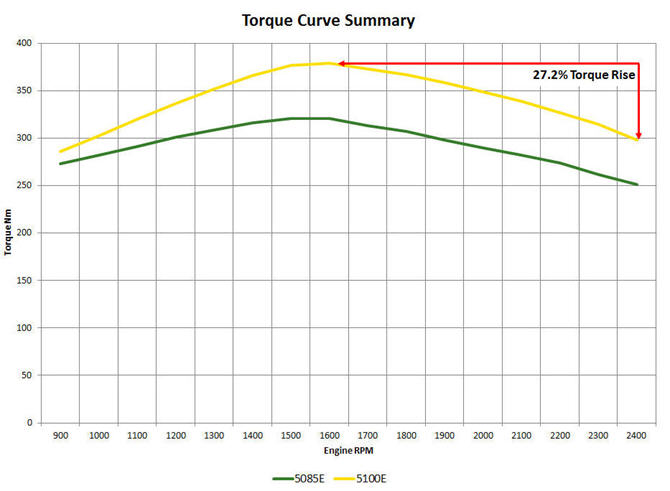 4-cylinder 5E torque curve summary
4-cylinder 5E torque curve summary
24F/12R PowrReverser™ transmission for more speed selection variety
This PowrReverser transmission provides 24 forward speeds and 12 reverse (24F/12R) speeds. This transmission comes standard with a dual speed 540/540 Economy power take-off (PTO), and is ideal for applications requiring frequent directional changes, such as loader work and PTO work like rotary cutting and baling hay.
Hydraulic wet forward and reverse clutches maximize durability and outlast the life of any dry clutch. When tractors are run by multiple operators with a variety of experience levels, a wet clutch is the best way to maintain transmission integrity and performance while decreasing clutch replacement costs.
Two platform-mounted levers offer easy and comfortable shifting. To distinguish the two levers for ease of operation, the gear-shift lever is longer and the less-used range lever is shorter. Unique knobs make it easy to distinguish between the two just by feel.
The hi/lo selector buttons are located on the gear shift lever for each forward gear, and are represented by a rabbit and a turtle respectively.
The forward lever selects one of four gears. All are synchronized for on-the-go shifting with the use of the clutch. The rear lever selects one of three ranges: A, B, or C.
 Gear shift lever with hi/lo buttons
Gear shift lever with hi/lo buttons

Maximum productivity is achieved with clutch-less hydraulic shifting between forward and reverse. PowrReverser functionality is ideal for rear blading and any applications that require frequent directional changes in tight spaces. An electrohydraulic fingertip directional lever control allows the operator to effortlessly switch directions with a small finger motion. The control is located on the left side of the instrument console and selects forward, reverse, and neutral positions. It also allows the operator to steer and shift direction with the left hand, freeing the right hand to operate other tractor controls, such as the loader, rear implements, or hand throttle. The PowrReverser has a built-in engagement override valve for additional safety. This valve requires the clutch pedal to be depressed one time after each engine start before the transmission will begin to operate normally, giving the operator another opportunity to put all focus on the tractor.
A neutral start switch requires the directional lever be in the neutral position to start the engine.
 Left hand reverser lever
Left hand reverser lever

The speed of directional changes can be adjusted to the operator's preference or application demands with an optional field installed infinitely variable control kit.
24F/12R transmission includes:
- Wet clutch
- Platform mounted shift levers 4 gears (with hi/lo selector in forward) and three ranges
- Left-hand reverser
- Constant-mesh helical-cut gears
- Pressure-lubricated top shaft
- Positive park pawl
- Neutral start switch
All tractors have economy PTO (E-PTO), a fuel-saving feature which allows customers to operate rear implements at 540 PTO rpm but at lower engine rpm. The result is lower engine vibration, reduced noise, less wear and tear on the engine, reduced fuel consumption and increased operator comfort.
See PTO Functional area for more information on E-PTO.
Cooling package design and serviceability
Every utility tractor customer wants to maximize uptime and appreciates enhanced performance. The newly designed cooling package on the Final Tier 4 (FT4) 4-cylinder 5E Tractors allows for easier access to and serviceability of certain critical components. This improvement to serviceability will save time and also enhance tractor performance.
The cooling package features a first-pass screen to catch larger debris, a slide-out condenser (only on cab tractors) a charge air cooler that tilts forward, and a hydraulic oil cooler that slides out halfway to both sides of the tractor.
 First pass screen
First pass screen
 Slide out condenser on cabs
Slide out condenser on cabs
 Charge air cooler tilted forward
Charge air cooler tilted forward
The engine is equipped with an electronically controlled fan drive, which means that it only runs as fast as the needs of the tractor demand at that time. This is a fuel-saving device which improves hydraulic cooling and reduces the noise level for the operator. It also positively impacts total fluid efficiency.
540/1000 power take-off (PTO) rpm kit for implement versatility
Customer needs drive us to deliver distinctive value in our solutions. The applications in which John Deere utility tractors, implements and attachments are used are growing by the day. A 540/1000 PTO rpm field-installed kit is available for the 5E Tractors. With this kit installed, operators can switch between standard 540 or 1000 PTO rpm based on the requirements of the implement. From rotary cutting, to shredding to snow throwing and baling, the capability to operate an implement requiring 1000 rear PTO rpm is available.
Once installation is complete, this solution offers the convenience of switching between 540 and 1000 PTO rpm with relative ease. Combined with the dry sump design, this attachment includes a reversible shaft. This provides for a less mess, no stress option that will enhance customer productivity and increase uptime.
 540/1000 PTO rpm field-installed kit
540/1000 PTO rpm field-installed kit
New LCD instrument cluster
An instrument cluster provides more information in a cleaner more vibrant display. The roll-mode function now has the ability to show more diagnostic codes to keep the operator informed about the tractor’s functionality.
This window into tractor functionality and diagnostics provides ample information. Indicators, warning lights, and even the gauges are clear and bright. The roll-mode function now provides operators with crucial onboard diagnostics. Engine hours, power take-off (PTO) speed, ground speed, hi-lo indicator, forward, neutral, and reverse, are all visible at the same time. There is a light out indicator for trailer light, turn light, and hazard light bulbs which is driven by updated software. It is a straightforward layout and sleek design with no customer interface required. When operating the PTO, there are clearly presented PTO target bars to indicate the correct PTO speed.
 Instrument cluster lights
Instrument cluster lights
There are daytime and nighttime modes which are based on the position of the light switch. The mode actually adjusts the backlight levels of the display for optimum visibility.
Features
A durable, mechanical front-wheel drive (MFWD) axle increases traction in tough conditions
 Heavy-duty MFWD front axle with limited slip
Heavy-duty MFWD front axle with limited slip
 MFWD 55-degree turn angle
MFWD 55-degree turn angle
 MFWD indicator light
MFWD indicator light
Limited-slip, heavy-duty MFWD front axle will provide operators with increased drawbar pull and improved traction when operating in slippery conditions. This ensures the operator gets the required torque to the ground for applications that demand more from the tractor. The MFWD front axle also reduces wheel slippage with less tractor ballasting for reduced soil compaction, increased fuel economy, and longer tire life.
The MFWD centerline design provides excellent maneuverability around the worksite and more crop clearance so producers aren't driving down their crop or profits. Additional versatility is proven when wheel treads are adjusted with 6 degrees of caster angle and a 55-degree turn angle, which results in a turning radius as short as 3 m (9.9 ft) (brakes applied), allowing plenty of horsepower to turn around in tight places. 10 degrees of axle oscillation follows uneven terrain, allowing for consistent performance and comfortable ride.
Axle oscillation also reduces the stress and maintenance cost on the axle spindles because loads are consistently spread across the entire axle. The centerline design eliminates the need for drive shaft universal joints that require regular maintenance. Anti-wrap shielding on the driveline is standard to prevent crop material and debris from building around the driveline and ensures tractor performance. Three grease points are conveniently located to minimize maintenance time while maximizing front axle performance.
NOTE: The MFWD engagement lever is located on the left-hand side of the operator's seat. For the operator’s convenience, when MFWD is engaged, an indicator light will appear on the dash.
Intuitive controls to aide in simple operation
Adding ease to operation
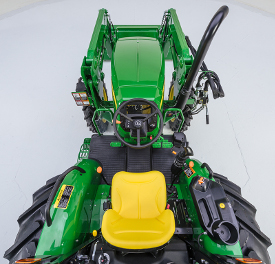 Enhanced operator controls
Enhanced operator controls
Operator comfort is important regardless of the application. Improving the 5E 3-Cylinder Tractor models, the hand throttle has been relocated to the right-hand console. This is 30.5 cm (12-in.) closer to the operator and within easy reach versus the previous location on the center-hand console. Operators may also notice the additional legroom provided by the repositioned loader controls, providing a more enjoyable experience.
9F/3R SyncShuttle™ transmission - An easy-to-use transmission which saves time and effort
Nine forward and three reverse speeds with in-line synchronized shuttle shifting
The SyncShuttle transmission is designed to match the excellent power and torque characteristics of the John Deere PowerTech™ engines. Transmission durability is enhanced with the pressure-lubricated top shaft, allowing an operator to achieve performance from one working season to the next. Additionally, this in-base transmission is configured with fixed draft links, single-speed power take-off (PTO) and mechanical PTO engagement.
The transmission is characterized as full top shaft synchronized (TSS) when forward shifting on-the-go between speeds, and is characterized a synchronized while depressing the clutch.
| 2100 engine rpm | ||
| 16.9-28 | ||
| Tire | 0.671 RR | |
| Gear | Rear Wheel Speed | Ground Speed |
| rpm | kmph | |
| A1 | 9.1 | 2.3 |
| A2 | 12.4 | 3.1 |
| A3 | 17.0 | 4.3 |
| A Rev | -13.5 | -3.4 |
| B1 | 23.1 | 5.8 |
| B2 | 31.4 | 7.9 |
| B3 | 43.2 | 10.9 |
| B Rev | -34.2 | -8.6 |
| C1 | 58.9 | 14.9 |
| C2 | 80.3 | 20.3 |
| C3 | 110.3 | 27.9 |
| C Rev | -87.3 | -22.1 |
Creeper available for R2 and R4 as field installed kit with following speeds in kmph.
| Creeper 1 | 0.40 |
| Creeper 2 | 0.54 |
| Creeper 3 | 0.75 |
| Creeper Rev | -0.59 |
Easy and comfortable shifting
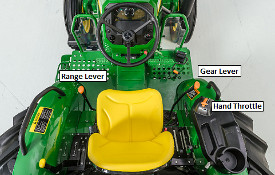 Operator-friendly transmission controls with hand throttle
Operator-friendly transmission controls with hand throttle
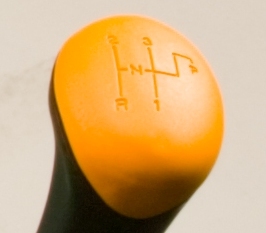 Synchronized shifting in all forward and reverse gears
Synchronized shifting in all forward and reverse gears
 Range selection pattern
Range selection pattern
Nine forward and three reverse (9F/3R) speeds are achieved by using two platform-mounted levers for shift operation. The gear lever at the operator's right hand selects one of three forward gears and one reverse gear, as well as the integrated park position. The range lever at the operator's left hand selects collar-shift A, B, and C ranges.
Operators can easily switch directions without having to completely stop the tractor with synchronized, in-line, shuttle-shift capability between forward and reverse gears on the gear-shift lever in all three ranges (A, B, and C ranges).
A neutral start switch requires the gear-shift lever be in the neutral or park positions to start the engine.
A positive park pawl on the transmission provides positive park and eliminates the need for a hand brake. This also eliminates clutch service costs that occur when the park brake is accidentally left engaged.
12F/12R PowrReverser™ transmission is ideal for demanding applications
 Electrohydraulic reverser lever
Electrohydraulic reverser lever
The John Deere-built PowrReverser transmission provides 12 forward and 12 reverse gears for operators requiring additional flexibility for multiple applications. It comes standard with shiftable 540/540 Economy power take-off (PTO) and electronically activated, telescoping draft links. This transmission is ideal for operators using their tractors to perform in versatile applications.
Hydraulic wet forward and reverse clutches maximize durability and will outlast the life of any dry clutch. When tractors are run by multiple operators with a variety of experience levels, a wet clutch is the best way to maintain transmission integrity and performance while decreasing clutch replacement costs.
The gear lever selects one of four speeds, all synchronized shifts for on-the-go shifting with the use of the clutch. The range lever selects collar-shift A, B, and C ranges, which are not synchronized.
Maximum productivity is achieved with hydraulic PowerShift between forward and reverse and is ideal for loader and rear-blade applications that require frequent directional switches in tight spaces. Excellent modulation allows the operator to shift the direction lever from neutral to forward or reverse, forward to reverse, reverse to forward, or to neutral from forward or reverse.
Operators can accomplish all these directional changes without sacrificing comfort or having to depress the clutch pedal. The speed of directional changes can be adjusted to the operator's preference or application demands with the field-installed infinitely-variable control kit.
The PowrReverser transmission also allows the operator to steer and shift direction with the left hand, freeing the right hand to operate other tractor controls, such as the loader, rear implements, or hand throttle.
 5075E
5075E
Constant-mesh, helical-cut gears provide quieter operation and excellent reliability while the pressure-lubricated top shaft adds to the transmission durability. Fully enclosed, rigid shift linkages for short throw and crisp shifts enable all operators to clearly know in what range and gear they are operating.
Positive park pawl on the transmission provides positive park and eliminates the need for a hand brake.
This also eliminates clutch service costs that occur when the park brake is accidentally left engaged. A neutral start switch requires the directional lever to be in the neutral position to start the engine.
Availability for 3-cylinder 5E Tractors:
Model |
12F/12R |
5045E (two-wheel drive [2WD]) |
|
5045E (mechanical front-wheel drive [MFWD]) |
|
5055E (2WD) |
|
5055E (MFWD) |
X |
5065E (2WD) |
|
5065E (MFWD) |
X |
5075E (2WD) |
|
5075E (MFWD) |
X |
X = Available
Final Tier 4-compliant PowerTech™ engines provide improved visibility
 A smaller, more efficient after-treatment device provides more space under the hood
A smaller, more efficient after-treatment device provides more space under the hood
The 5045E, 5055E, 5065E, and 5075E Utility Tractors meet U.S. Environmental Protection Agency (EPA) Final Tier 4 (FT4) exhaust emissions regulations with a diesel oxidation catalyst (DOC)/diesel particulate filter (DPF) system. Modifying the after-treatment device resulted in better forward and side visibility around the hood. The hood slope of the updated design is comparable to the Tier 2 tractors previously produced. Similar to the system on the 5M, the purpose of the DOC/DPF combination is to reduce toxic gases emitted from the exhaust, as well as to filter particulate matter to prevent it from becoming airborne.
As the tractor continues to operate over time, as is the case with any filter, the DPF will accumulate particulate matter and will need to be cleaned. It is cleaned through a process called regeneration. During a regeneration cycle, exhaust temperatures increase to burn off the excess particulate matter. On a John Deere 5 Series Tractor equipped with a DOC/DPF, the operator does not need to provide any input to trigger the regeneration process.
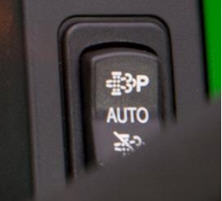 Exhaust filter cleaning switch
Exhaust filter cleaning switch
On the dash is an exhaust filter cleaning switch. As long as this switch remains in the auto position, the tractor is in full control of the regeneration process and will regenerate on an as-needed basis during operation. The operator just continues to operate the tractor as normal while the regeneration process takes place.
There may be times a tractor is operating in an environment not suitable for a regeneration cycle, such as in a confined area or during service. For this reason, the bottom section of the exhaust filter cleaning switch can be depressed to disable the regeneration. The disable position allows the operator to temporarily inhibit the regeneration cycle. The operator should return the switch to auto mode as soon as possible to avoid continued soot buildup in the exhaust filter, which can lead to a parked regeneration. John Deere does not recommend disabling the automatic exhaust filter cleaning unless it is absolutely necessary.
The simplicity and intuitiveness of the exhaust filter cleaning switch maximizes uptime by minimizing the operator’s input into the regeneration process. This increases the overall productivity of the tractor by reducing the chances of a parked regeneration. The operator-friendly interface allows the operator to easily complete the task at hand, even during the regeneration process.
Save fuel, reduce noise, and increase engine life in power take-off (PTO) applications with the 540/540 economy PTO
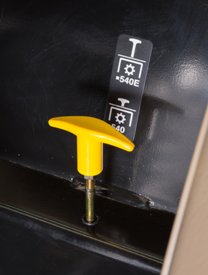 Shiftable 540/540 economy PTO (5E) for cab tractors
Shiftable 540/540 economy PTO (5E) for cab tractors
 Shiftable 540/540 economy PTO (5E) for open operator station (OOS) tractors
Shiftable 540/540 economy PTO (5E) for open operator station (OOS) tractors
The 540 economy PTO option comes in base equipment with the 12F/12R PowrReverser™ transmission.
The 540/540 economy PTO allows operators to select the engine rpm for reduced fuel consumption, reduced noise levels, reduced vibration, and less wear and tear on the engine, while at the same time keeping the proper 540 rpm at the PTO.
The economy PTO provides 540 rpm to the PTO at 1600 engine rpm. The 540 economy mode is ideal for any PTO application, from running a mower-conditioner to a baler or a cutter, where full engine horsepower is not required.
Operating at lower engine rpm decreases fuel costs up to 30 percent and provides additional productivity by improving the operating experience through enhanced operator comfort from reduced noise and vibration.
A lever allows the operator to simply change between 540 and 540E when conditions merit the opportunity to save fuel without affecting performance.
For heavy-duty operations requiring maximum PTO power, the PTO shift lever is placed in the 540 position, the PTO is engaged, and the engine is run at a rated speed of 2100 rpm. This selection gives 540 rpm to the PTO shaft and delivers the fully advertised horsepower at rated engine speed.
When the cab tractor is in economy PTO mode, the engine is electronically limited to 1600 rpm, preventing accidental over speeding of PTO implements and protecting against binding the PTO shaft.
This interlock also prevents accidental shifting of the PTO selector lever at engine speeds above 1600 rpm, which would lead to downtime for fixing implements or drivetrain components.
Features
A durable, mechanical front-wheel drive (MFWD) axle increases traction in tough conditions
 Heavy-duty MFWD front axle with limited slip
Heavy-duty MFWD front axle with limited slip
 MFWD 55-degree turn angle
MFWD 55-degree turn angle
 MFWD indicator light
MFWD indicator light
Limited-slip, heavy-duty MFWD front axle will provide operators with increased drawbar pull and improved traction when operating in slippery conditions. This ensures the operator gets the required torque to the ground for applications that demand more from the tractor. The MFWD front axle also reduces wheel slippage with less tractor ballasting for reduced soil compaction, increased fuel economy, and longer tire life.
The MFWD centerline design provides excellent maneuverability around the worksite and more crop clearance so producers aren't driving down their crop or profits. Additional versatility is proven when wheel treads are adjusted with 6 degrees of caster angle and a 55-degree turn angle, which results in a turning radius as short as 3 m (9.9 ft) (brakes applied), allowing plenty of horsepower to turn around in tight places. 10 degrees of axle oscillation follows uneven terrain, allowing for consistent performance and comfortable ride.
Axle oscillation also reduces the stress and maintenance cost on the axle spindles because loads are consistently spread across the entire axle. The centerline design eliminates the need for drive shaft universal joints that require regular maintenance. Anti-wrap shielding on the driveline is standard to prevent crop material and debris from building around the driveline and ensures tractor performance. Three grease points are conveniently located to minimize maintenance time while maximizing front axle performance.
NOTE: The MFWD engagement lever is located on the left-hand side of the operator's seat. For the operator’s convenience, when MFWD is engaged, an indicator light will appear on the dash.
Intuitive controls to aide in simple operation
Adding ease to operation
 Enhanced operator controls
Enhanced operator controls
Operator comfort is important regardless of the application. Improving the 5E 3-Cylinder Tractor models, the hand throttle has been relocated to the right-hand console. This is 30.5 cm (12-in.) closer to the operator and within easy reach versus the previous location on the center-hand console. Operators may also notice the additional legroom provided by the repositioned loader controls, providing a more enjoyable experience.
9F/3R SyncShuttle™ transmission - An easy-to-use transmission which saves time and effort
Nine forward and three reverse speeds with in-line synchronized shuttle shifting
The SyncShuttle transmission is designed to match the excellent power and torque characteristics of the John Deere PowerTech™ engines. Transmission durability is enhanced with the pressure-lubricated top shaft, allowing an operator to achieve performance from one working season to the next. Additionally, this in-base transmission is configured with fixed draft links, single-speed power take-off (PTO) and mechanical PTO engagement.
The transmission is characterized as full top shaft synchronized (TSS) when forward shifting on-the-go between speeds, and is characterized a synchronized while depressing the clutch.
| 2100 engine rpm | ||
| 16.9-28 | ||
| Tire | 0.671 RR | |
| Gear | Rear Wheel Speed | Ground Speed |
| rpm | kmph | |
| A1 | 9.1 | 2.3 |
| A2 | 12.4 | 3.1 |
| A3 | 17.0 | 4.3 |
| A Rev | -13.5 | -3.4 |
| B1 | 23.1 | 5.8 |
| B2 | 31.4 | 7.9 |
| B3 | 43.2 | 10.9 |
| B Rev | -34.2 | -8.6 |
| C1 | 58.9 | 14.9 |
| C2 | 80.3 | 20.3 |
| C3 | 110.3 | 27.9 |
| C Rev | -87.3 | -22.1 |
Creeper available for R2 and R4 as field installed kit with following speeds in kmph.
| Creeper 1 | 0.40 |
| Creeper 2 | 0.54 |
| Creeper 3 | 0.75 |
| Creeper Rev | -0.59 |
Easy and comfortable shifting
 Operator-friendly transmission controls with hand throttle
Operator-friendly transmission controls with hand throttle
 Synchronized shifting in all forward and reverse gears
Synchronized shifting in all forward and reverse gears
 Range selection pattern
Range selection pattern
Nine forward and three reverse (9F/3R) speeds are achieved by using two platform-mounted levers for shift operation. The gear lever at the operator's right hand selects one of three forward gears and one reverse gear, as well as the integrated park position. The range lever at the operator's left hand selects collar-shift A, B, and C ranges.
Operators can easily switch directions without having to completely stop the tractor with synchronized, in-line, shuttle-shift capability between forward and reverse gears on the gear-shift lever in all three ranges (A, B, and C ranges).
A neutral start switch requires the gear-shift lever be in the neutral or park positions to start the engine.
A positive park pawl on the transmission provides positive park and eliminates the need for a hand brake. This also eliminates clutch service costs that occur when the park brake is accidentally left engaged.
12F/12R PowrReverser™ transmission is ideal for demanding applications
 Electrohydraulic reverser lever
Electrohydraulic reverser lever
The John Deere-built PowrReverser transmission provides 12 forward and 12 reverse gears for operators requiring additional flexibility for multiple applications. It comes standard with shiftable 540/540 Economy power take-off (PTO) and electronically activated, telescoping draft links. This transmission is ideal for operators using their tractors to perform in versatile applications.
Hydraulic wet forward and reverse clutches maximize durability and will outlast the life of any dry clutch. When tractors are run by multiple operators with a variety of experience levels, a wet clutch is the best way to maintain transmission integrity and performance while decreasing clutch replacement costs.
The gear lever selects one of four speeds, all synchronized shifts for on-the-go shifting with the use of the clutch. The range lever selects collar-shift A, B, and C ranges, which are not synchronized.
Maximum productivity is achieved with hydraulic PowerShift between forward and reverse and is ideal for loader and rear-blade applications that require frequent directional switches in tight spaces. Excellent modulation allows the operator to shift the direction lever from neutral to forward or reverse, forward to reverse, reverse to forward, or to neutral from forward or reverse.
Operators can accomplish all these directional changes without sacrificing comfort or having to depress the clutch pedal. The speed of directional changes can be adjusted to the operator's preference or application demands with the field-installed infinitely-variable control kit.
The PowrReverser transmission also allows the operator to steer and shift direction with the left hand, freeing the right hand to operate other tractor controls, such as the loader, rear implements, or hand throttle.
 5075E
5075E
Constant-mesh, helical-cut gears provide quieter operation and excellent reliability while the pressure-lubricated top shaft adds to the transmission durability. Fully enclosed, rigid shift linkages for short throw and crisp shifts enable all operators to clearly know in what range and gear they are operating.
Positive park pawl on the transmission provides positive park and eliminates the need for a hand brake.
This also eliminates clutch service costs that occur when the park brake is accidentally left engaged. A neutral start switch requires the directional lever to be in the neutral position to start the engine.
Availability for 3-cylinder 5E Tractors:
Model |
12F/12R |
5045E (two-wheel drive [2WD]) |
|
5045E (mechanical front-wheel drive [MFWD]) |
|
5055E (2WD) |
|
5055E (MFWD) |
X |
5065E (2WD) |
|
5065E (MFWD) |
X |
5075E (2WD) |
|
5075E (MFWD) |
X |
X = Available
Final Tier 4-compliant PowerTech™ engines provide improved visibility
 A smaller, more efficient after-treatment device provides more space under the hood
A smaller, more efficient after-treatment device provides more space under the hood
The 5045E, 5055E, 5065E, and 5075E Utility Tractors meet U.S. Environmental Protection Agency (EPA) Final Tier 4 (FT4) exhaust emissions regulations with a diesel oxidation catalyst (DOC)/diesel particulate filter (DPF) system. Modifying the after-treatment device resulted in better forward and side visibility around the hood. The hood slope of the updated design is comparable to the Tier 2 tractors previously produced. Similar to the system on the 5M, the purpose of the DOC/DPF combination is to reduce toxic gases emitted from the exhaust, as well as to filter particulate matter to prevent it from becoming airborne.
As the tractor continues to operate over time, as is the case with any filter, the DPF will accumulate particulate matter and will need to be cleaned. It is cleaned through a process called regeneration. During a regeneration cycle, exhaust temperatures increase to burn off the excess particulate matter. On a John Deere 5 Series Tractor equipped with a DOC/DPF, the operator does not need to provide any input to trigger the regeneration process.
 Exhaust filter cleaning switch
Exhaust filter cleaning switch
On the dash is an exhaust filter cleaning switch. As long as this switch remains in the auto position, the tractor is in full control of the regeneration process and will regenerate on an as-needed basis during operation. The operator just continues to operate the tractor as normal while the regeneration process takes place.
There may be times a tractor is operating in an environment not suitable for a regeneration cycle, such as in a confined area or during service. For this reason, the bottom section of the exhaust filter cleaning switch can be depressed to disable the regeneration. The disable position allows the operator to temporarily inhibit the regeneration cycle. The operator should return the switch to auto mode as soon as possible to avoid continued soot buildup in the exhaust filter, which can lead to a parked regeneration. John Deere does not recommend disabling the automatic exhaust filter cleaning unless it is absolutely necessary.
The simplicity and intuitiveness of the exhaust filter cleaning switch maximizes uptime by minimizing the operator’s input into the regeneration process. This increases the overall productivity of the tractor by reducing the chances of a parked regeneration. The operator-friendly interface allows the operator to easily complete the task at hand, even during the regeneration process.
Save fuel, reduce noise, and increase engine life in power take-off (PTO) applications with the 540/540 economy PTO
 Shiftable 540/540 economy PTO (5E) for cab tractors
Shiftable 540/540 economy PTO (5E) for cab tractors
 Shiftable 540/540 economy PTO (5E) for open operator station (OOS) tractors
Shiftable 540/540 economy PTO (5E) for open operator station (OOS) tractors
The 540 economy PTO option comes in base equipment with the 12F/12R PowrReverser™ transmission.
The 540/540 economy PTO allows operators to select the engine rpm for reduced fuel consumption, reduced noise levels, reduced vibration, and less wear and tear on the engine, while at the same time keeping the proper 540 rpm at the PTO.
The economy PTO provides 540 rpm to the PTO at 1600 engine rpm. The 540 economy mode is ideal for any PTO application, from running a mower-conditioner to a baler or a cutter, where full engine horsepower is not required.
Operating at lower engine rpm decreases fuel costs up to 30 percent and provides additional productivity by improving the operating experience through enhanced operator comfort from reduced noise and vibration.
A lever allows the operator to simply change between 540 and 540E when conditions merit the opportunity to save fuel without affecting performance.
For heavy-duty operations requiring maximum PTO power, the PTO shift lever is placed in the 540 position, the PTO is engaged, and the engine is run at a rated speed of 2100 rpm. This selection gives 540 rpm to the PTO shaft and delivers the fully advertised horsepower at rated engine speed.
When the cab tractor is in economy PTO mode, the engine is electronically limited to 1600 rpm, preventing accidental over speeding of PTO implements and protecting against binding the PTO shaft.
This interlock also prevents accidental shifting of the PTO selector lever at engine speeds above 1600 rpm, which would lead to downtime for fixing implements or drivetrain components.
Features
A durable, mechanical front-wheel drive (MFWD) axle increases traction in tough conditions
 Heavy-duty MFWD front axle with limited slip
Heavy-duty MFWD front axle with limited slip
 MFWD 55-degree turn angle
MFWD 55-degree turn angle
 MFWD indicator light
MFWD indicator light
Limited-slip, heavy-duty MFWD front axle will provide operators with increased drawbar pull and improved traction when operating in slippery conditions. This ensures the operator gets the required torque to the ground for applications that demand more from the tractor. The MFWD front axle also reduces wheel slippage with less tractor ballasting for reduced soil compaction, increased fuel economy, and longer tire life.
The MFWD centerline design provides excellent maneuverability around the worksite and more crop clearance so producers aren't driving down their crop or profits. Additional versatility is proven when wheel treads are adjusted with 6 degrees of caster angle and a 55-degree turn angle, which results in a turning radius as short as 3 m (9.9 ft) (brakes applied), allowing plenty of horsepower to turn around in tight places. 10 degrees of axle oscillation follows uneven terrain, allowing for consistent performance and comfortable ride.
Axle oscillation also reduces the stress and maintenance cost on the axle spindles because loads are consistently spread across the entire axle. The centerline design eliminates the need for drive shaft universal joints that require regular maintenance. Anti-wrap shielding on the driveline is standard to prevent crop material and debris from building around the driveline and ensures tractor performance. Three grease points are conveniently located to minimize maintenance time while maximizing front axle performance.
NOTE: The MFWD engagement lever is located on the left-hand side of the operator's seat. For the operator’s convenience, when MFWD is engaged, an indicator light will appear on the dash.
Intuitive controls to aide in simple operation
Adding ease to operation
 Enhanced operator controls
Enhanced operator controls
Operator comfort is important regardless of the application. Improving the 5E 3-Cylinder Tractor models, the hand throttle has been relocated to the right-hand console. This is 30.5 cm (12-in.) closer to the operator and within easy reach versus the previous location on the center-hand console. Operators may also notice the additional legroom provided by the repositioned loader controls, providing a more enjoyable experience.
9F/3R SyncShuttle™ transmission - An easy-to-use transmission which saves time and effort
Nine forward and three reverse speeds with in-line synchronized shuttle shifting
The SyncShuttle transmission is designed to match the excellent power and torque characteristics of the John Deere PowerTech™ engines. Transmission durability is enhanced with the pressure-lubricated top shaft, allowing an operator to achieve performance from one working season to the next. Additionally, this in-base transmission is configured with fixed draft links, single-speed power take-off (PTO) and mechanical PTO engagement.
The transmission is characterized as full top shaft synchronized (TSS) when forward shifting on-the-go between speeds, and is characterized a synchronized while depressing the clutch.
| 2100 engine rpm | ||
| 16.9-28 | ||
| Tire | 0.671 RR | |
| Gear | Rear Wheel Speed | Ground Speed |
| rpm | kmph | |
| A1 | 9.1 | 2.3 |
| A2 | 12.4 | 3.1 |
| A3 | 17.0 | 4.3 |
| A Rev | -13.5 | -3.4 |
| B1 | 23.1 | 5.8 |
| B2 | 31.4 | 7.9 |
| B3 | 43.2 | 10.9 |
| B Rev | -34.2 | -8.6 |
| C1 | 58.9 | 14.9 |
| C2 | 80.3 | 20.3 |
| C3 | 110.3 | 27.9 |
| C Rev | -87.3 | -22.1 |
Creeper available for R2 and R4 as field installed kit with following speeds in kmph.
| Creeper 1 | 0.40 |
| Creeper 2 | 0.54 |
| Creeper 3 | 0.75 |
| Creeper Rev | -0.59 |
Easy and comfortable shifting
 Operator-friendly transmission controls with hand throttle
Operator-friendly transmission controls with hand throttle
 Synchronized shifting in all forward and reverse gears
Synchronized shifting in all forward and reverse gears
 Range selection pattern
Range selection pattern
Nine forward and three reverse (9F/3R) speeds are achieved by using two platform-mounted levers for shift operation. The gear lever at the operator's right hand selects one of three forward gears and one reverse gear, as well as the integrated park position. The range lever at the operator's left hand selects collar-shift A, B, and C ranges.
Operators can easily switch directions without having to completely stop the tractor with synchronized, in-line, shuttle-shift capability between forward and reverse gears on the gear-shift lever in all three ranges (A, B, and C ranges).
A neutral start switch requires the gear-shift lever be in the neutral or park positions to start the engine.
A positive park pawl on the transmission provides positive park and eliminates the need for a hand brake. This also eliminates clutch service costs that occur when the park brake is accidentally left engaged.
12F/12R PowrReverser™ transmission is ideal for demanding applications
 Electrohydraulic reverser lever
Electrohydraulic reverser lever
The John Deere-built PowrReverser transmission provides 12 forward and 12 reverse gears for operators requiring additional flexibility for multiple applications. It comes standard with shiftable 540/540 Economy power take-off (PTO) and electronically activated, telescoping draft links. This transmission is ideal for operators using their tractors to perform in versatile applications.
Hydraulic wet forward and reverse clutches maximize durability and will outlast the life of any dry clutch. When tractors are run by multiple operators with a variety of experience levels, a wet clutch is the best way to maintain transmission integrity and performance while decreasing clutch replacement costs.
The gear lever selects one of four speeds, all synchronized shifts for on-the-go shifting with the use of the clutch. The range lever selects collar-shift A, B, and C ranges, which are not synchronized.
Maximum productivity is achieved with hydraulic PowerShift between forward and reverse and is ideal for loader and rear-blade applications that require frequent directional switches in tight spaces. Excellent modulation allows the operator to shift the direction lever from neutral to forward or reverse, forward to reverse, reverse to forward, or to neutral from forward or reverse.
Operators can accomplish all these directional changes without sacrificing comfort or having to depress the clutch pedal. The speed of directional changes can be adjusted to the operator's preference or application demands with the field-installed infinitely-variable control kit.
The PowrReverser transmission also allows the operator to steer and shift direction with the left hand, freeing the right hand to operate other tractor controls, such as the loader, rear implements, or hand throttle.
 5075E
5075E
Constant-mesh, helical-cut gears provide quieter operation and excellent reliability while the pressure-lubricated top shaft adds to the transmission durability. Fully enclosed, rigid shift linkages for short throw and crisp shifts enable all operators to clearly know in what range and gear they are operating.
Positive park pawl on the transmission provides positive park and eliminates the need for a hand brake.
This also eliminates clutch service costs that occur when the park brake is accidentally left engaged. A neutral start switch requires the directional lever to be in the neutral position to start the engine.
Availability for 3-cylinder 5E Tractors:
Model |
12F/12R |
5045E (two-wheel drive [2WD]) |
|
5045E (mechanical front-wheel drive [MFWD]) |
|
5055E (2WD) |
|
5055E (MFWD) |
X |
5065E (2WD) |
|
5065E (MFWD) |
X |
5075E (2WD) |
|
5075E (MFWD) |
X |
X = Available
Final Tier 4-compliant PowerTech™ engines provide improved visibility
 A smaller, more efficient after-treatment device provides more space under the hood
A smaller, more efficient after-treatment device provides more space under the hood
The 5045E, 5055E, 5065E, and 5075E Utility Tractors meet U.S. Environmental Protection Agency (EPA) Final Tier 4 (FT4) exhaust emissions regulations with a diesel oxidation catalyst (DOC)/diesel particulate filter (DPF) system. Modifying the after-treatment device resulted in better forward and side visibility around the hood. The hood slope of the updated design is comparable to the Tier 2 tractors previously produced. Similar to the system on the 5M, the purpose of the DOC/DPF combination is to reduce toxic gases emitted from the exhaust, as well as to filter particulate matter to prevent it from becoming airborne.
As the tractor continues to operate over time, as is the case with any filter, the DPF will accumulate particulate matter and will need to be cleaned. It is cleaned through a process called regeneration. During a regeneration cycle, exhaust temperatures increase to burn off the excess particulate matter. On a John Deere 5 Series Tractor equipped with a DOC/DPF, the operator does not need to provide any input to trigger the regeneration process.
 Exhaust filter cleaning switch
Exhaust filter cleaning switch
On the dash is an exhaust filter cleaning switch. As long as this switch remains in the auto position, the tractor is in full control of the regeneration process and will regenerate on an as-needed basis during operation. The operator just continues to operate the tractor as normal while the regeneration process takes place.
There may be times a tractor is operating in an environment not suitable for a regeneration cycle, such as in a confined area or during service. For this reason, the bottom section of the exhaust filter cleaning switch can be depressed to disable the regeneration. The disable position allows the operator to temporarily inhibit the regeneration cycle. The operator should return the switch to auto mode as soon as possible to avoid continued soot buildup in the exhaust filter, which can lead to a parked regeneration. John Deere does not recommend disabling the automatic exhaust filter cleaning unless it is absolutely necessary.
The simplicity and intuitiveness of the exhaust filter cleaning switch maximizes uptime by minimizing the operator’s input into the regeneration process. This increases the overall productivity of the tractor by reducing the chances of a parked regeneration. The operator-friendly interface allows the operator to easily complete the task at hand, even during the regeneration process.
Save fuel, reduce noise, and increase engine life in power take-off (PTO) applications with the 540/540 economy PTO
 Shiftable 540/540 economy PTO (5E) for cab tractors
Shiftable 540/540 economy PTO (5E) for cab tractors
 Shiftable 540/540 economy PTO (5E) for open operator station (OOS) tractors
Shiftable 540/540 economy PTO (5E) for open operator station (OOS) tractors
The 540 economy PTO option comes in base equipment with the 12F/12R PowrReverser™ transmission.
The 540/540 economy PTO allows operators to select the engine rpm for reduced fuel consumption, reduced noise levels, reduced vibration, and less wear and tear on the engine, while at the same time keeping the proper 540 rpm at the PTO.
The economy PTO provides 540 rpm to the PTO at 1600 engine rpm. The 540 economy mode is ideal for any PTO application, from running a mower-conditioner to a baler or a cutter, where full engine horsepower is not required.
Operating at lower engine rpm decreases fuel costs up to 30 percent and provides additional productivity by improving the operating experience through enhanced operator comfort from reduced noise and vibration.
A lever allows the operator to simply change between 540 and 540E when conditions merit the opportunity to save fuel without affecting performance.
For heavy-duty operations requiring maximum PTO power, the PTO shift lever is placed in the 540 position, the PTO is engaged, and the engine is run at a rated speed of 2100 rpm. This selection gives 540 rpm to the PTO shaft and delivers the fully advertised horsepower at rated engine speed.
When the cab tractor is in economy PTO mode, the engine is electronically limited to 1600 rpm, preventing accidental over speeding of PTO implements and protecting against binding the PTO shaft.
This interlock also prevents accidental shifting of the PTO selector lever at engine speeds above 1600 rpm, which would lead to downtime for fixing implements or drivetrain components.
Features
A durable, mechanical front-wheel drive (MFWD) axle increases traction in tough conditions
 Heavy-duty MFWD front axle with limited slip
Heavy-duty MFWD front axle with limited slip
 MFWD 55-degree turn angle
MFWD 55-degree turn angle
 MFWD indicator light
MFWD indicator light
Limited-slip, heavy-duty MFWD front axle will provide operators with increased drawbar pull and improved traction when operating in slippery conditions. This ensures the operator gets the required torque to the ground for applications that demand more from the tractor. The MFWD front axle also reduces wheel slippage with less tractor ballasting for reduced soil compaction, increased fuel economy, and longer tire life.
The MFWD centerline design provides excellent maneuverability around the worksite and more crop clearance so producers aren't driving down their crop or profits. Additional versatility is proven when wheel treads are adjusted with 6 degrees of caster angle and a 55-degree turn angle, which results in a turning radius as short as 3 m (9.9 ft) (brakes applied), allowing plenty of horsepower to turn around in tight places. 10 degrees of axle oscillation follows uneven terrain, allowing for consistent performance and comfortable ride.
Axle oscillation also reduces the stress and maintenance cost on the axle spindles because loads are consistently spread across the entire axle. The centerline design eliminates the need for drive shaft universal joints that require regular maintenance. Anti-wrap shielding on the driveline is standard to prevent crop material and debris from building around the driveline and ensures tractor performance. Three grease points are conveniently located to minimize maintenance time while maximizing front axle performance.
NOTE: The MFWD engagement lever is located on the left-hand side of the operator's seat. For the operator’s convenience, when MFWD is engaged, an indicator light will appear on the dash.
Intuitive controls to aide in simple operation
Adding ease to operation
 Enhanced operator controls
Enhanced operator controls
Operator comfort is important regardless of the application. Improving the 5E 3-Cylinder Tractor models, the hand throttle has been relocated to the right-hand console. This is 30.5 cm (12-in.) closer to the operator and within easy reach versus the previous location on the center-hand console. Operators may also notice the additional legroom provided by the repositioned loader controls, providing a more enjoyable experience.
9F/3R SyncShuttle™ transmission - An easy-to-use transmission which saves time and effort
Nine forward and three reverse speeds with in-line synchronized shuttle shifting
The SyncShuttle transmission is designed to match the excellent power and torque characteristics of the John Deere PowerTech™ engines. Transmission durability is enhanced with the pressure-lubricated top shaft, allowing an operator to achieve performance from one working season to the next. Additionally, this in-base transmission is configured with fixed draft links, single-speed power take-off (PTO) and mechanical PTO engagement.
The transmission is characterized as full top shaft synchronized (TSS) when forward shifting on-the-go between speeds, and is characterized a synchronized while depressing the clutch.
| 2100 engine rpm | ||
| 16.9-28 | ||
| Tire | 0.671 RR | |
| Gear | Rear Wheel Speed | Ground Speed |
| rpm | kmph | |
| A1 | 9.1 | 2.3 |
| A2 | 12.4 | 3.1 |
| A3 | 17.0 | 4.3 |
| A Rev | -13.5 | -3.4 |
| B1 | 23.1 | 5.8 |
| B2 | 31.4 | 7.9 |
| B3 | 43.2 | 10.9 |
| B Rev | -34.2 | -8.6 |
| C1 | 58.9 | 14.9 |
| C2 | 80.3 | 20.3 |
| C3 | 110.3 | 27.9 |
| C Rev | -87.3 | -22.1 |
Creeper available for R2 and R4 as field installed kit with following speeds in kmph.
| Creeper 1 | 0.40 |
| Creeper 2 | 0.54 |
| Creeper 3 | 0.75 |
| Creeper Rev | -0.59 |
Easy and comfortable shifting
 Operator-friendly transmission controls with hand throttle
Operator-friendly transmission controls with hand throttle
 Synchronized shifting in all forward and reverse gears
Synchronized shifting in all forward and reverse gears
 Range selection pattern
Range selection pattern
Nine forward and three reverse (9F/3R) speeds are achieved by using two platform-mounted levers for shift operation. The gear lever at the operator's right hand selects one of three forward gears and one reverse gear, as well as the integrated park position. The range lever at the operator's left hand selects collar-shift A, B, and C ranges.
Operators can easily switch directions without having to completely stop the tractor with synchronized, in-line, shuttle-shift capability between forward and reverse gears on the gear-shift lever in all three ranges (A, B, and C ranges).
A neutral start switch requires the gear-shift lever be in the neutral or park positions to start the engine.
A positive park pawl on the transmission provides positive park and eliminates the need for a hand brake. This also eliminates clutch service costs that occur when the park brake is accidentally left engaged.
Final Tier 4-compliant PowerTech™ engines provide improved visibility
 A smaller, more efficient after-treatment device provides more space under the hood
A smaller, more efficient after-treatment device provides more space under the hood
The 5045E, 5055E, 5065E, and 5075E Utility Tractors meet U.S. Environmental Protection Agency (EPA) Final Tier 4 (FT4) exhaust emissions regulations with a diesel oxidation catalyst (DOC)/diesel particulate filter (DPF) system. Modifying the after-treatment device resulted in better forward and side visibility around the hood. The hood slope of the updated design is comparable to the Tier 2 tractors previously produced. Similar to the system on the 5M, the purpose of the DOC/DPF combination is to reduce toxic gases emitted from the exhaust, as well as to filter particulate matter to prevent it from becoming airborne.
As the tractor continues to operate over time, as is the case with any filter, the DPF will accumulate particulate matter and will need to be cleaned. It is cleaned through a process called regeneration. During a regeneration cycle, exhaust temperatures increase to burn off the excess particulate matter. On a John Deere 5 Series Tractor equipped with a DOC/DPF, the operator does not need to provide any input to trigger the regeneration process.
 Exhaust filter cleaning switch
Exhaust filter cleaning switch
On the dash is an exhaust filter cleaning switch. As long as this switch remains in the auto position, the tractor is in full control of the regeneration process and will regenerate on an as-needed basis during operation. The operator just continues to operate the tractor as normal while the regeneration process takes place.
There may be times a tractor is operating in an environment not suitable for a regeneration cycle, such as in a confined area or during service. For this reason, the bottom section of the exhaust filter cleaning switch can be depressed to disable the regeneration. The disable position allows the operator to temporarily inhibit the regeneration cycle. The operator should return the switch to auto mode as soon as possible to avoid continued soot buildup in the exhaust filter, which can lead to a parked regeneration. John Deere does not recommend disabling the automatic exhaust filter cleaning unless it is absolutely necessary.
The simplicity and intuitiveness of the exhaust filter cleaning switch maximizes uptime by minimizing the operator’s input into the regeneration process. This increases the overall productivity of the tractor by reducing the chances of a parked regeneration. The operator-friendly interface allows the operator to easily complete the task at hand, even during the regeneration process.
Features
Attractive styling provides improved visibility and serviceability
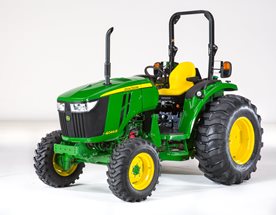 4R Tractor
4R Tractor

The bold styling of the 4M and 4R Tractors provide an attractive and functional appearance similar to that of the larger agricultural tractors. Benefits of this styling include:
- Easy tractor family identification
- Updated fixed grille and side panel hood design allows for optimum sealing of the cooling compartment
- Front grille slides up to an integrated maintenance position for easy battery access
- Easily removable cowl, allowing for serviceability access
- Wraparound-style halogen headlights
- Premium integrated automotive style headlight bezels
- Bold graphics
- Aggressively sloped hood design, giving a softer, smoother look and providing improved visibility
- Hybrid exhaust in base on cab tractors for clear operator visibility and safety
- At low speed and when tractor is in a filter cleaning process, exhaust will be routed through vertical exhaust outlet. In all other cases, the exhaust will be routed through the downward exhaust outlet.
- Side exhaust in base on open operator station tractors and ensures minimal heat impact to operator
The result gives the tractor a distinctive appearance and feel.
NOTE: If the tractor is equipped with an optional field-installed vertical exhaust, exhaust pipe must be removed before opening and closing the hood of the tractor.
Powerful Yanmar® diesel engine delivers plenty of power under heavy loads
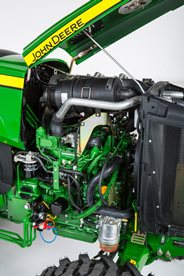 Powerful Yanmar engine
Powerful Yanmar engine
The Yanmar diesel engine has a high-torque reserve that provides plenty of power under heavy load.
This 4-cylinder engine features lower levels of exhaust emissions and reduced noise levels. It meets EPA Final Tier 4 (FT4) emission standards.
Model |
Number of |
Engine |
Aspiration |
Rated |
Gross engine |
Gross engine ps* |
PTO hp |
4 |
2.2 L |
Natural |
42.5 |
43.1 |
32.5 |
||
4052M/R |
4 |
2.1 L |
Turbocharged |
50.8 |
51.5 |
39.9 |
|
4066M/R |
4 |
2.1 L |
Turbocharged |
2600 |
65.0 |
65.9 |
52.0 |
Displacement, cu in. (L):134.25 (2.2)
*Engine hp (kW), gross SAE J1995: 51.5 (37.9) at 2600 rpm, PS
Displacement, cu in. (L):128.15 (2.1)
*Engine hp (kW), gross SAE J1995: 65.9 (48.5) at 2600 rpm, PS
Displacement, cu in. (L):128.15 (2.1)
The engine uses the latest technologies to optimize fuel economy, improve control and accuracy, and reduce environmental impact.
The common rail system (CRS) optimizes fuel economy and reduces operating costs*. High-pressure injection atomizes fuel into finer particles which burn more completely. It results in improved fuel economy and lower cost of operation.
The electronic control unit (ECU) provides optimum fuel control and accuracy. ECU monitors and controls the engine. It continuously monitors engine conditions and adjusts the fuel delivery accordingly to ensure optimum performance and emissions.
The new engine comes with an after treatment system. The system operates automatically. The exhaust filter consists of a diesel particulate filter (DPF) which captures particulate matter (PM) contained in the exhaust gas. Using a natural cleaning process, most of the PM trapped in the exhaust filter is eliminated by the heat of the exhaust stream generated by normal use. In situations of low temperature, engine speed or load factor, an active cleaning cycle is initiated. In this cleaning cycle, the exhaust gas temperature is raised by injecting additional fuel during the exhaust stroke of normal vehicle operation to the diesel oxidation catalyst (DOC).
After many hours of use, the exhaust filter may require an ash removal service.
NOTE: *As compared to engines not using CRS technology.
DPF cleaning
Depending on the load that the tractor is under, as well as ambient temperature, humidity, and engine speed, the DPF may build up with particulate matter, thus requiring cleaning. Filter cleaning is determined by one of three conditions:
- A prescribed time-based estimation of needed filter cleaning
- DOC/DPF pressure sensors
- A particulate matter buildup estimation based on load conditions
Once one of the three conditions has been met, filter cleaning will occur.
There are three different types of filter cleaning processes:
- Passive filter cleaning
- Active filter cleaning
- Parked filter cleaning
Passive filter cleaning
Passive filter cleaning occurs naturally when the engine is generating enough heat to oxidize particulate matter. This automatic process occurs continuously during normal operating conditions. No tractor icons or symbols appear on the display during passive filter cleaning.
NOTE: Passive filter cleaning requires no operator involvement, and there is no interruption to tractor operation.
Active filter cleaning
If conditions (temperature, load, or speed) for passive filter cleaning cannot be achieved, then PM is removed using active filter cleaner.
To achieve the required conditions, exhaust temperature management (ETM) manages the initiation and duration of active filter cleaning. ETM can adjust numerous engine parameters and/or inject a small quantity of fuel into the exhaust stream for a short duration. The fuel turns to vapor and chemically reacts with the catalysts in the DOC to create heat to oxidize PM.
It is important to note that at no time is the fuel in the DOC/DPF ignited, and there is no flame within the DOC/DPF.
Like passive filter cleaning, active filter cleaning requires no operator involvement, and there is no interruption to tractor operation.
Parked filter cleaning
In some instances where passive and active filter cleaning have not fully cleaned the PM from the system, a parked filter cleaning may need to take place. Most likely, the only time a parked filter cleaning will need to occur is when automatic filter cleaning has been disabled for an extended period of time and multiple warnings to engage filter cleaning were ignored or if the tractor has been used during light load conditions. Additionally, when the automatic filter cleaning process has been deliberately interrupted multiple times, or if active filter cleaning has failed numerous times due to a failed component, a parked filter cleaning may be requested. In these rare instances the operator will have to park the tractor and start the filter cleaning process.
The parked filter cleaning process needs to be activated based on usage and operation of the tractor. The process will take approximately 30 minutes. See operator’s manual for more details.
This system constantly monitors the soot level of the tractor, making sure the tractor is always in peak performance condition. This ensures high performance at all times.
NOTE: Number of hours since last regeneration and soot level percentage viewable on LCD display.
Key features of the engine are:
- Lower rated speed for 540 rpm power take-off (PTO) operation means better fuel economy, less noise and vibration, and longer overall engine life
- Cast-in-block cylinder design for good cooling and long life
- Hydraulic lifters are quieter and require no adjustment
- Heavy-duty crankshaft provides more bearing surface area for added durability
- CRS optimizes fuel economy, lowering the cost of operation
- ECU provides optimum control and accuracy
- Direct fuel injection
- Improves starting
- Injects fuel directly on top of pistons for more efficient combustion
- Develops more horsepower per gallon of fuel
- Glow plugs (cold starting aid)
- Engine oil cooler, cools engine oil for longer engine life
- Key start and shutoff eliminates fuel shutoff knob
- Electric solenoid shuts fuel supply off immediately when key is turned off
- See-through coolant recovery tank permits operator to check coolant level without removing radiator cap
- Sealed radiator compartment keeps trash and debris on outside of hood
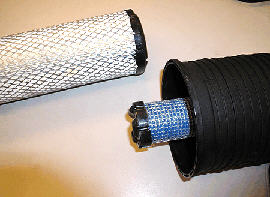 Dry-type air cleaner
Dry-type air cleaner

- Dry-type air cleaner with safety element and electronic air service indicator
- Electronic air restriction indicator alerts operator when air filter servicing is required
- Dual-element design for added engine protection
- Easy to service
- Standard side exhaust
- Discharges fumes away from the operator, reducing engine noise
- Improves operator visibility when using a loader or front implement
- Optional vertical exhaust
Yanmar is a trademark of Yanmar Company Limited.
PowrReverser™ transmission allows for clutchless direction changes
PowrReverser transmission allows for clutchless direction changes
 PowrReverser transmission lever
PowrReverser transmission lever
The 12/12 PowrReverser transmission is available on the 4M and 4R Tractors.
The PowrReverser transmission offers a hydraulically shifted forward-to-reverse transmission. This allows for clutchless shuttle shifting between forward and reverse with one lever for quick and easy direction change.
- PowrReverser transmission does not require the operator to use the clutch to shift between forward and reverse
The PowrReverser transmission features a hydraulically actuated wet clutch. Two multi-disk clutch packs (one forward and one reverse) are hydraulically engaged when the directional (reverser) lever is placed in either the forward or reverse position.
Each clutch pack consists of three large, 5-in. diameter clutch disks that operate in oil and are oil-cooled, allowing excellent heat dissipation and extended clutch life.
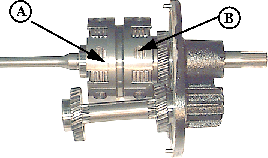 Forward/reverse clutches
Forward/reverse clutches
- Clutch A is used for the forward operation of the tractor
- Clutch B is used for the reverse operation of the tractor
Key features of the PowrReverser transmission:
- 12 forward/12 reverse (12F/12R) speeds
- Reverser lever, located on the left side of the instrument console, allows the operator to make direction changes without clutching
- Fast shuttle shift for improved loader operation
- Dual-cone synchronizers allow for synchronized shifts between gears for on-the-go shifting with the use of the clutch
- Dual-cone synchronizers permit on-the-go, low-effort shifting between gears
- Helical-cut gears for quiet operation
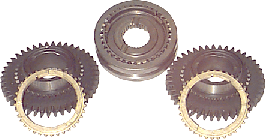 Helical-cut gears
Helical-cut gears

- Well-spaced speeds for turf, loader, and transport work
- Neutral start switch prevents tractor from starting when transmission (main range) is not in neutral
- Dual wet-disk clutches provide long clutch life
- Shifts between ranges are not synchronized
- PowrReverser transmission models have both hand and foot throttle controls
- Especially handy when using a loader
Maximize productivity with an eHydro™ transmission
The tractor is available with a three-range electronic hydrostatic (eHydro) transmission.
- Fluid under pressure transmits engine power to the drive wheels using a pump and motor
- Functions both as a clutch and transmission
- Provides high torque for startup
- Reduces powertrain shock loads
Danfoss® supplies both the pump and motor. This ensures that the components are matched to each other, providing maximum efficiency.
The electronic hydrostatic transmission is ideally suited for jobs where productivity is a must, such as loader or mower applications.
Twin Touch™ foot controls allow the operator to select both directions of travel and speed with a touch of the toe.
Key features of the eHydro transmission:
- Infinitely variable ground speeds, in each range, allow the operator to match the speed of the tractor to the job.
- No clutching for fast and easy direction changes
- Twin Touch foot pedals for quick and easy forward/reverse operation
- Cruise control is standard equipment
- Cruise control switch is located on the right-hand console for easy access
- Cruise control is electronically engaged and disengaged, which allows for precise setting of speed
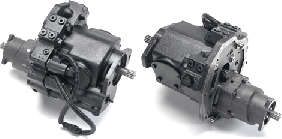 Danfoss eHydro transmission
Danfoss eHydro transmission

Danfoss eHydro transmission is used for reliable operation. Durability features include:
- Large forged trunnion shaft with larger support bearings that reduce vibration and noise.
- Center section made from ductile iron (much stronger than grey iron used in many competitive transmissions).
- Transmission oil cooler cools transmission oil for longer transmission life.
Safety features of the eHydro transmission include:
- The tractor will start with one or both foot pedals depressed, but it will not move until both pedals first return to neutral
- Operator presence - the tractor will come to a stop if the operator leaves the seat but will not shut off unless the power take-off (PTO) is also running
Key John Deere advantage
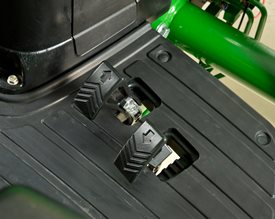 Twin Touch foot controls
Twin Touch foot controls

John Deere's Twin Touch foot controls offer several key advantages over competitive hydro model tractors.
- Some competitive hydrostatic tractors use a treadle pedal (toe-heel) design foot control for operation of the hydro
- Requires the operator to use both toe and heel to change direction, resulting in increased operator fatigue
Integrated eHydro features
The eHydro convenience controls have been integrated into a single module. Combining features such as SpeedMatch™ LoadMatch™, MotionMatch™ eThrottle™ and automotive style cruise control pulls the maximum efficiency out of the eHydro transmission tractors. All of these features are standard on the 4R models, and deliver customers an easier and more comfortable experience.
 eHydro convenience control module
eHydro convenience control module

|
Press button to active/deactivate eThrottle. When eThrottle is activated, depression of the travel pedal increases engine RPM and tractor speed. |
|
Press button to active/deactivate LoadMatch. When LoadMatch is activated, engine will not stall during heavy load applications. |
|
Press button to activate/deactivate SpeedMatch. When SpeedMatch is activated, operator is able to set the desired maximum travel speed. |
|
Press button to activate/deactivate cruise control. When cruise control is activated, operator is able to set cruise speed. |
|
Press button to set cruise speed, or to decrease cruise/set max speed. |
|
Press button to resume set cruise speed, or to increase cruise/set max speed. |
|
MotionMatch - longer accelerate and decelerate distances. |
|
MotionMatch - shorter accelerate and decelerate distances. |
eThrottle
 eThrottle indicator
eThrottle indicator

Press a button to activate/deactivate eThrottle™. When eThrottle is activated, depression of travel pedal increases engine rpm and tractor speed simultaneously. This provides the operator with comfort and convenience as well as fuel economy.
Automotive-style cruise control
 Cruise control indicator
Cruise control indicator

An automotive-style cruise control is standard equipment on the 4R Series Tractors. Cruise control is electronically engaged and disengaged and is located on the right-hand operator console.
- Maintains desired forward speed without pressure on the foot pedal
- When activated, the operator is able to set cruise speed
- Use the SET/- button to set cruise speed, or to decrease cruise/max speed
- Use the RES/+ button to set cruise speed, or to increase cruise/max speed
- A speed sensor also allows the tractor to maintain preset speed driving up and down hills
- To disengage the cruise control, either:
- Apply pressure to the brakes
- Disengage cruise control button
- Briefly depress the reverse travel pedal
LoadMatch™ power management system
 LoadMatch indicator
LoadMatch indicator

LoadMatch is a standard feature on the 4R Series Tractors.
If torque requirements increase significantly, the transmission will reduce the tractor's drive speed to compensate for the increased load on the transmission, maximizing torque to drive wheels and minimizing stalls.
Controls automatically adjust LoadMatch compensation depending on the tractor’s application. PTO applications require less engine speed fluctuation, therefore adjusting the amount of droop depending on PTO speed. This adjustment increases efficiency and optimizes engine speed and torque output based on tractor application.
While typically left on, LoadMatch can be turned off with the right-hand console controls.
MotionMatch™
The MotionMatch, standard on the 4R Series Tractors, is located on the right-hand console. It offers seven settings for adjusting the rollout or decelerating when the pedal is released.
 MotionMatch indicator
MotionMatch indicator

Longer accelerate and decelerate distances.
 MotionMatch indicator
MotionMatch indicator

Shorter accelerate and decelerate distances.
SpeedMatch™
 SpeedMatch indicator
SpeedMatch indicator

SpeedMatch, standard on the 4R Series Tractors, further enhances the eHydro cruise control functions by allowing the operator to preset maximum speed. Once this feature is engaged, the operator must stroke the travel pedal fully to meet the operator’s preset speed and press the Set button to lock the speed. From there, the operator can use the automotive-style cruise controls to adjust speed. This function will improve accuracy and safety, particularly at lower travel speed applications.
Rotary tilling or spraying applications are examples of where SpeedMatch can be applied. SpeedMatch will work in both the forward and reverse set speeds.
NOTE: Automotive-style cruise control and SpeedMatch can be used in conjunction with LoadMatch to maximize productivity.
Danfoss is a trademark of Danfoss Incorporated.
Operator station is comfortable and convenient
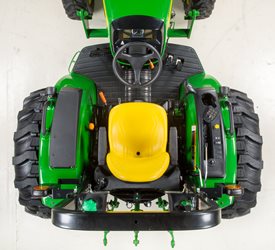 Easy entry and exit from the operator's station
Easy entry and exit from the operator's station

The operator's station is designed for easy entry and exit from the tractor.
Conveniently placed brake pedals, as well as repositioned operator controls, provide for a clean and flat platform design giving the operator plenty of legroom.
- Hood and fenders are made from composite polymer material designed to eliminate the possibility of rusting and resistance to dents that can occur with metal hoods and fenders. This material provides a high-luster appearance with excellent resilience and resistance to fading from sunlight.
- Easy-fold rollover protective structure (ROPS), with built-in, rattle reducing, tension rod.
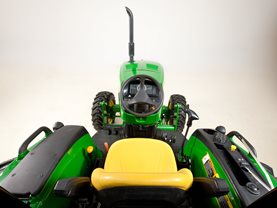 Comfortable and convenient design
Comfortable and convenient design

Key features of the operator's station include:
- Large grab handles on each fender make getting on and off the tractor easy
- Foot platform is rubber mounted and incorporates a rubber mat for operator comfort
- Center console and fender toolboxes provide ample storage
- Large cup holder on right-hand fender
- Fender-mounted forward work lights (two lights)
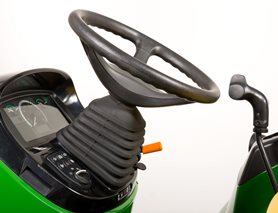 Adjustable, tilt steering wheel
Adjustable, tilt steering wheel

- Improved tilt steering wheel design is in base equipment. The tilt wheel:
- Allows the operator to adjust the steering wheel to the most comfortable position
- Provides additional clearance for the operator to enter and exit the tractor
- Provides easy return to fully raised position
- Provides plenty of room for comfortable operation
- Controls are shape and color-coded for easier identification and operation
- 12-V outlet is standard on the 4R Tractors. It provides power for mobile devices
- Integrated junction block provides switched and unswitched power to add additional accessories
 Left-side step
Left-side step

-
A left-side step is in base equipment to enhance access to the operator's station
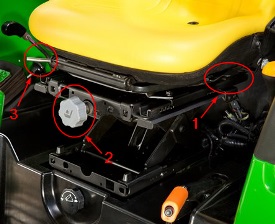 Adjustable scissor-type suspension seat
Adjustable scissor-type suspension seat

- Swivel seat adjustment (1) with armrests, in base equipment on all 4R open station tractors, to decrease operator fatigue when operating rear driven implements. Seat swivels 15 degrees in either direction. Also provides convenience and comfort while entering and exiting the tractor.
- Air suspension seat optional for the 4R Series Tractors.
- Air suspension not compatible with swivel function.
- Air suspension seat optional for the 4R Series Tractors.
- The scissor-type suspension seat gives the operator a comfortable ride. The seat flips forward for protection from the elements.
- Seat suspension is adjustable for the operator's weight and height.
- Operator weight adjustment (2) adjusts to the operator’s weight (115 lb to 275 lb)
- The seat is adjustable fore and aft for the operator’s height using the lever (3) located under the seat
- Retractable seat belts prevent belts from becoming tangled in seat suspension and controls.
Optional premium ComfortGard™ cab provides superior comfort and performance
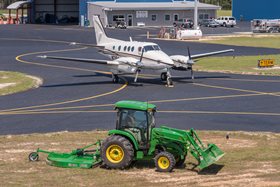 ComfortGard cab
ComfortGard cab

John Deere ComfortGard cab tractors are the most comfortable, quiet, and easy-to-use cab tractors available. This premium solution was developed using extensive customer research and validation, tools, and some of the most advanced design techniques available.
The following John Deere ComfortGard cab tractor models are available:
- 4044R eHydro™
- 4052R eHydro
- 4066R eHydro
Cab tractors are designed for those who demand superior performance:
-
Large-property owners
-
Commercial operators
-
Governmental agencies
- Growers
Whether using a loader to move dirt or remove snow or doing a variety of other tasks like mowing, tilling, rotary cutting, or light hay work, the cab tractors have the versatility and muscle to get the job done, all while protecting the operator from the elements.
Design
 State-of-the-art design
State-of-the-art design

-
Designed and built by John Deere
-
Certified to the highest safety standards in the industry
-
Fingertip controls and an automotive-like fit and finish
Operators are sure to appreciate what this cab has to offer – beginning with an isolated cab. These cabs are designed with robust mounting points integrated into the rollover protective structure (ROPS) with a unique offset mounting design that provides an ultra-quiet ride.
A 4-post ROPS design, carefully laid-out interior, and fuel tank located under the left rear side of the operator's platform provide a full 360 degrees of visibility:
-
Operators will enjoy a commanding view no matter what task is being performed.
-
The raised header bar design allows operators – whether short or tall – to see the loader bucket or pallet forks through virtually the full range of operation.
-
Operator fatigue caused by awkward bending is reduced, leading to an increase in overall productivity.
-
The slow-moving vehicle (SMV) sign can be easily removed and stored in the operator's manual holder to provide a clear and unobstructed view for attaching to implements and doing field work.
-
Ample headroom and curved glass on all four sides provide a spacious interior and give operators the feel of a large-tractor cab.
Operators are well-protected from the elements with a high-performance climate-control system providing heating and air conditioning.
-
The climate-control system makes any task more enjoyable whether on a frigid winter day or a hot summer day.
-
The cab is tightly sealed to help reduce exposure to dust and allergens.
-
A standard high-efficiency clean-air filter keeps even the smallest dust and allergen particles out.
-
Improved HVAC system with larger capacity condenser cools the cab faster in a hot climate.
Cab comfort features
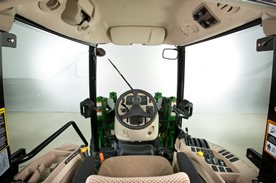 Superior operator comfort
Superior operator comfort
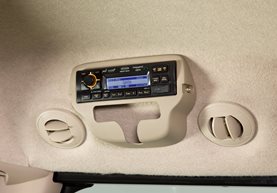 Optional radio kit
Optional radio kit
Several features are integrated into the design of the cab that deliver superior operator comfort and visibility:
- Ultra-quiet interior
- Superior cooling performance
- 4-post ROPS with curved glass for 360-degree visibility and spacious interior
- High-performance climate-control system for maximum operator comfort
- Raised header bar for maximum loader visibility
- Right-hand control center with the most frequently used controls at the operator's fingertips
- Left-hand automotive-style park brake
- Dash-mounted four-wheel drive (4WD) engagement, so there is no awkward bending
- Standard tilt steering
- Improved shift range linkage for ease in operation
- Flat unobstructed foot platform
- 4044R and 4052R has a deluxe cloth seat with a retractable seat belt and armrests, which provides excellent back support
- 4066R comes equipped with an air suspension seat, providing ultimate comfort and reduced operator fatigue
- Inside rearview mirror for rear visibility
- Optional dual exterior rearview mirrors for added rear visibility
- Ergonomically placed integrated loader joystick control for maximum comfort during operation
- Interior dome light with on, door, and off positions for illumination in low-light conditions
- Optional field- or factory-installed stereo with Jensen® receiver, weather band, auxiliary port and powered USB port
- SWJHD1630 stereo with AM/FM, weather band, SIRIUS® Satellite, and iPod® ready can be ordered separately through Parts
- Standard sun visor to block unwanted sunlight
- Creature comforts like:
- Dual cup holders
- 12-V power supply
- Cell phone storage
- Hitch pin storage
- Miscellaneous storage
- Operator's manual holder
- Integrated handle for convenient support for entering and exiting
- Left-side step for convenient entrance and exit
Cab operating features
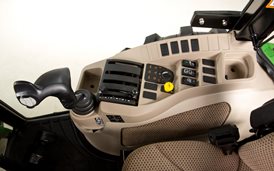 Right-hand control panel
Right-hand control panel
 Side-post mounting bosses
Side-post mounting bosses
 Installing rear window removable plug
Installing rear window removable plug
 Rear window removable plug installed
Rear window removable plug installed
- Pre-wired for optional accessories like radio, horn, rear work lights, electric hydraulic diverter, third electrohydraulic selective control valve (SCV), dual rear SCV, rear wiper/washer, beacon light, and cigarette lighter
- Optional field-installed stereo with Jensen receiver, weather band, auxiliary port and powered USB port
- Integrated warning lights/turn signals and taillights, protected from trees and branches
- Integrated roof-mounted antenna, protected from potential damage from trees and branches
- Dual roof-mounted forward work lights for optimum forward visibility at night
- Standard two-speed front windshield wiper to keep the front glass clear
- Standard rear wiper on the deluxe cab keeps the rear glass clear (Standard on the 4066R Deluxe Cab model.)
- Optional front fenders to protect the front cab glass from mud and debris
- Optional rear fender extensions to help protect the doors from mud and debris
- High-impact polymer fenders, dent resistant and painted to an automotive-like finish
- Rear glass that swings out 70 degrees for ventilation or access to the optional iMatch™ hitch
- Easy access to route and mount the controller or monitor through the rear window removable plug and mounting bosses on the side post
- Large, 13-gal. fuel tank for longer operation without refueling
- Left-rear fender fuel fill with large opening for easy refueling
- Fuel tank located under the left side of the operator's station for maximum rear visibility
Cab safety features
-
ROPS – certified to the highest industry standards for maximum operator protection
-
Operator presence system
-
Engine shuts down if the operator leaves the seat when the any power take-off (PTO) is engaged
-
Tractor must have the park brake fully set for stationary PTO work
-
Right-side emergency exit
-
Tempered safety glass in case of breakage
-
Roof-mounted warning lights/turn signals for road transport – two front and two rear
-
Two fender-mounted taillights
-
Removable slow-moving vehicle sign can be easily removed and stored in the operator's manual holder
4044R/4052R standard cloth seat
A deluxe cloth seat with a retractable seat belt is in base equipment:
-
An ergonomically sculpted seat cushion, an adjustable scissor-link suspension, and seat armrests are combined to provide excellent operator comfort and support.
-
The scissor-link suspension can be adjusted for the operator's height and weight.
-
The operator weight adjustment adjusts to the operator's weight (115 lb to 275 lb).
-
Seat is adjustable fore and aft for the operator's height, using the lever located under the seat.
-
Retractable seat belts prevent the belts from becoming tangled in the seat suspension and controls.
-
Optional air-suspension seat is available.
4066R Deluxe air-suspension seat
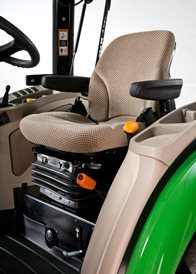 Air-suspension seat
Air-suspension seat

An air-ride seat is standard on the 4066R Cab Tractor and is available as an option on the 4044R and 4052R Cab models. This seat is designed to provide an air cushion for vertical-seat travel which provides maximum operator comfort in any terrain.
The deluxe air-ride seat is a field-installed option on the 4044R and 4052R Cab Tractor.
Seat features:
- Push the button at the base of the seat to pump up the seat. Pull the button to deflate the seat.
- The seat slides fore-aft with a lever on the right-hand side of the seat.
- The seat back reclines with the lever in the lower-left corner of the seat cushion.
The optional field-installed air-suspension kit requires the existing standard seat to be reused when installed.
NOTE: The deluxe two-piece seat top may be ordered through Parts.
Key benefits include:
- Maximum-ride comfort and quality, thus minimizing operator fatigue
- Dampens lower frequency vibration better than mechanical suspensions
- Increased operator weight capacity of 330 lb
- Closeout boot for enhanced appearance
Lighting equipment
The base lighting package for cab tractors includes:
- Two wide-angle halogen headlights
- Two roof-mounted, adjustable halogen forward work lights, which illuminate the work area in low-light conditions
- Two roof-mounted, adjustable halogen rear work lights, which illuminate the work area in low-light conditions (4066R Deluxe Cab models only)
- Two front and two rear amber turn signals/warning lights integrated into the cab roof
- Two taillights integrated into the fenders
- Three-position (on/off/auto) interior dome light
Optional lighting
 Adjustable rear work lights
Adjustable rear work lights
Optional lighting includes:
- Dual roof-mounted adjustable rear work lights (in base equipment on the 4066R Deluxe Cab only)
- Rotating beacon light (field-installed kit only for both base and deluxe cab offerings)
Jensen is a trademark of ASA Electronics Corporation. iPod is a trademark of Apple Incorporated. SIRIUS is a trademark of SIRIUS XM Radio Inc.
Built-in safety features for operator peace of mind
Safety is designed into all 4M and 4R Series Tractors.
- Operator presence system ensures the operator is in the seat to run the tractor
- If the operator leaves the seat when front or rear power take-off (PTO) is engaged, the engine shuts down.
- For stationary PTO work, the tractor must be in neutral and the park brake fully set.
- The rollover protective structure (ROPS) is designed for operation safety
- Reflective ROPS strips for better tractor visibility
- Key switch interlock prevents bypass starting
- Visual PTO warning light alerts operator when rear PTO is running
- Placing the transmission in neutral and setting the park brake allows operator to run rear PTO safely when off the tractor seat
- Turn signal and flashing warning lights operate according to ASAE S279.10 standard
- Taillights for road transport
- Slow moving vehicle (SMV) sign for road transport
Hitch assist, auxiliary 3-point hitch control, and optional iMatch™ Quick-Hitch for easy implement hookup
Hitch assist (ground positioning)
The hitch assist feature allows the operator to creep the tractor backward/forward while standing behind the tractor. Engaging and operation includes the following steps:
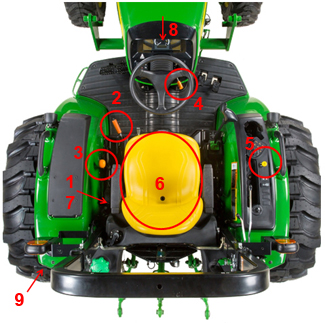 Hitch assist
Hitch assist

- Ensure hitch assist switch is in off position (A below)
- Engage the park brake
- Select A range
- Set to low throttle
- Ensure power take-off (PTO) is off
- Operator must be in the tractor’s seat
- Activate the hitch assist switch
a. If successful, flashers will trigger
b. If not, the missing interlock will be displayed on the LCD screen - Once flashers are triggered, if the operator leaves the seat, the display will beep indicating that the hitch assist is in remote mode
- Operator moves to back of the tractor, start motion of the tractor using the enable button (B below) and corresponding direction button (C below)
a. Push and hold both buttons continuously as long as motion is desired - Audible alarm will sound indicating motion of the tractor
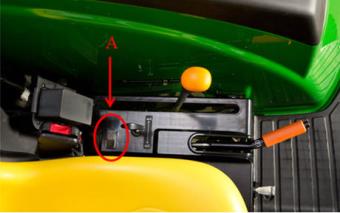 Hitch assist switch
Hitch assist switch
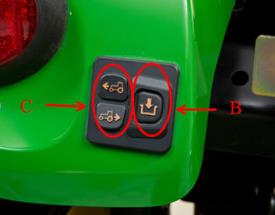 Enable and directional buttons
Enable and directional buttons
Auxiliary 3-point hitch control
The new auxiliary 3-point hitch control, on the left-hand fender, allows the operator to raise or lower the hitch while standing on the ground behind the tractor.
Pairing the auxiliary 3-point hitch control with hitch assist, changing implements has never been easier. Both features are in base equipment for 4R Series eHydro™ models.
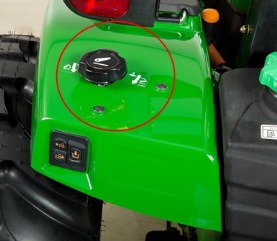 Auxiliary 3-point hitch control (open station tractor)
Auxiliary 3-point hitch control (open station tractor)
 Auxiliary 3-point hitch control (cab tractor)
Auxiliary 3-point hitch control (cab tractor)
iMatch Quick-Hitch
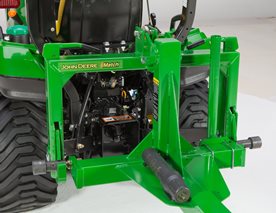 iMatch Quick-Hitch (LVB25976)
iMatch Quick-Hitch (LVB25976)
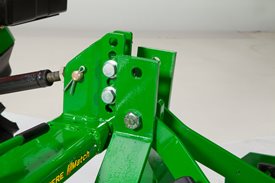 iMatch Quick-Hitch with rotary cutter hookup (LVB25976)
iMatch Quick-Hitch with rotary cutter hookup (LVB25976)
One of the greatest customer concerns involves difficulty in attaching tractor implements. John Deere has addressed this issue with the iMatch Quick-Hitch.
The iMatch Quick-Hitch provides easy hookup and a guaranteed fit for all Category 1 implements that are designed to meet the ASAE Category 1 Standard S278.6 for quick-attach hitches.
- All implements require a set of bushings in order for the attachment to fit and work properly with the iMatch Quick-Hitch. One set of bushings comes with the iMatch Quick-Hitch.
NOTE: The bushing set can be seen in the picture above. These bushings allow the hooks on the iMatch and the pins on the implement to fit together properly. All other implements (box blades, tillers, rear blades, etc.) will require a set of bushings to enlarge the pin to fit with the iMatch hooks. Bushings of different lengths can be found in the Parts system or through a bushing supplier (see dimensions below).
- Upper bushing
- Inside diameter: 1.93-1.06 cm (0.76-0.77 in.)
- Outside diameter: 3.15 to 3.43 cm (1.24-1.25 in.)
- Lower bushings
- Inside diameter: 2.24 to 2.26 cm (0.88 to 0.89 in.)
- Outside diameter: 3.63 to 3.66 cm (1.43 to 1.44 in.)
Save fuel, reduce noise, and increase engine life with the economy power take-off (PTO)
The optional field-installed 540/540 economy power take-off (PTO) allows operators to select the engine rpm needed for their PTO application. The economy position provides 540 rpm to the PTO at approximately 70 percent of the engine's normal rated speed. The engine runs at a rated speed of approximately 1750 rpm in the 540 economy position. The 540 economy is ideal for any PTO application, from running a mower to a baler or a cutter, where full horsepower is not needed. Operating at lower engine rpm decreases fuel costs during tasks. The overall operating experience improves because there is less noise and vibration for the operator.
A conveniently located lever (behind the seat of the tractor) allows the operator to simply change between 540 and 540E when conditions merit the opportunity to save fuel without affecting performance. For heavy-duty operations that require maximum PTO power, the PTO shift lever is placed in the 540 position, the PTO engaged, and the engine is run at rated speed of 2400 rpm. This selection gives 540 rpm to the PTO shaft and delivers the full-advertised horsepower at rated engine speed.
The 540/540 economy PTO offers all the features of the standard 540-rpm PTO, and the safety interlock
is a foolproof measure provided to compensate for operator oversight. When the tractor is in economy,
the engine is limited to a lower operating speed, preventing accidental over speeding of PTO implements
and protecting against binding the PTO shaft. The safety interlock also prevents accidental shifting of
the PTO selector lever at higher engine speeds than the economy PTO setting, which would lead to
downtime to fix implements or drivetrains.
Excellent serviceability reduces operational costs and improves productivity
Regular service and maintenance are essential to the performance, productivity, and longevity of the tractor.
- Easy access to regular service points minimizes service time.
- Easily removable cowl and side panels, improved hood design, and integrated maintenance position on the grille provide easy accessibility for routine maintenance.
- Tractors are equipped with extensive onboard self-diagnostic capabilities and are fully compatible with John Deere’s exclusive Service ADVISOR™ system.
- Daily service requirements are minimal and simple to accomplish. Most service interval requirements can be performed with a basic understanding of procedures and common tools.
- Improved cost of ownership
- Hydraulic oil service interval changed from 400 to 1200 hours (or 3 years) when using Hy-Gard™ products
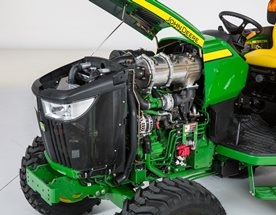 Removable side panels
Removable side panels
 Integrated grille maintenance position
Integrated grille maintenance position
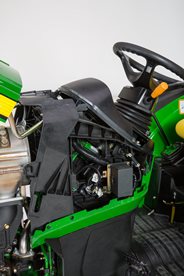 Removable cowl
Removable cowl
All items in the daily service schedule can be performed without the use of tools:
- Engine oil, hydraulic oil, coolant level, and the water separator can be conveniently accessed
- The engine can be easily accessed by simply raising the hood for more periodic maintenance checks
- A single-point latch mechanism and self-contained leash ensure easy hood opening and closure
NOTE: Always refer to the operator’s manual for complete maintenance and service recommendations.
Features
Attractive styling provides improved visibility and serviceability
 4R Tractor
4R Tractor

The bold styling of the 4M and 4R Tractors provide an attractive and functional appearance similar to that of the larger agricultural tractors. Benefits of this styling include:
- Easy tractor family identification
- Updated fixed grille and side panel hood design allows for optimum sealing of the cooling compartment
- Front grille slides up to an integrated maintenance position for easy battery access
- Easily removable cowl, allowing for serviceability access
- Wraparound-style halogen headlights
- Premium integrated automotive style headlight bezels
- Bold graphics
- Aggressively sloped hood design, giving a softer, smoother look and providing improved visibility
- Hybrid exhaust in base on cab tractors for clear operator visibility and safety
- At low speed and when tractor is in a filter cleaning process, exhaust will be routed through vertical exhaust outlet. In all other cases, the exhaust will be routed through the downward exhaust outlet.
- Side exhaust in base on open operator station tractors and ensures minimal heat impact to operator
The result gives the tractor a distinctive appearance and feel.
NOTE: If the tractor is equipped with an optional field-installed vertical exhaust, exhaust pipe must be removed before opening and closing the hood of the tractor.
Powerful Yanmar® diesel engine delivers plenty of power under heavy loads
 Powerful Yanmar engine
Powerful Yanmar engine
The Yanmar diesel engine has a high-torque reserve that provides plenty of power under heavy load.
This 4-cylinder engine features lower levels of exhaust emissions and reduced noise levels. It meets EPA Final Tier 4 (FT4) emission standards.
Model |
Number of |
Engine |
Aspiration |
Rated |
Gross engine |
Gross engine ps* |
PTO hp |
4 |
2.2 L |
Natural |
42.5 |
43.1 |
32.5 |
||
4052M/R |
4 |
2.1 L |
Turbocharged |
50.8 |
51.5 |
39.9 |
|
4066M/R |
4 |
2.1 L |
Turbocharged |
2600 |
65.0 |
65.9 |
52.0 |
Displacement, cu in. (L):134.25 (2.2)
*Engine hp (kW), gross SAE J1995: 51.5 (37.9) at 2600 rpm, PS
Displacement, cu in. (L):128.15 (2.1)
*Engine hp (kW), gross SAE J1995: 65.9 (48.5) at 2600 rpm, PS
Displacement, cu in. (L):128.15 (2.1)
The engine uses the latest technologies to optimize fuel economy, improve control and accuracy, and reduce environmental impact.
The common rail system (CRS) optimizes fuel economy and reduces operating costs*. High-pressure injection atomizes fuel into finer particles which burn more completely. It results in improved fuel economy and lower cost of operation.
The electronic control unit (ECU) provides optimum fuel control and accuracy. ECU monitors and controls the engine. It continuously monitors engine conditions and adjusts the fuel delivery accordingly to ensure optimum performance and emissions.
The new engine comes with an after treatment system. The system operates automatically. The exhaust filter consists of a diesel particulate filter (DPF) which captures particulate matter (PM) contained in the exhaust gas. Using a natural cleaning process, most of the PM trapped in the exhaust filter is eliminated by the heat of the exhaust stream generated by normal use. In situations of low temperature, engine speed or load factor, an active cleaning cycle is initiated. In this cleaning cycle, the exhaust gas temperature is raised by injecting additional fuel during the exhaust stroke of normal vehicle operation to the diesel oxidation catalyst (DOC).
After many hours of use, the exhaust filter may require an ash removal service.
NOTE: *As compared to engines not using CRS technology.
DPF cleaning
Depending on the load that the tractor is under, as well as ambient temperature, humidity, and engine speed, the DPF may build up with particulate matter, thus requiring cleaning. Filter cleaning is determined by one of three conditions:
- A prescribed time-based estimation of needed filter cleaning
- DOC/DPF pressure sensors
- A particulate matter buildup estimation based on load conditions
Once one of the three conditions has been met, filter cleaning will occur.
There are three different types of filter cleaning processes:
- Passive filter cleaning
- Active filter cleaning
- Parked filter cleaning
Passive filter cleaning
Passive filter cleaning occurs naturally when the engine is generating enough heat to oxidize particulate matter. This automatic process occurs continuously during normal operating conditions. No tractor icons or symbols appear on the display during passive filter cleaning.
NOTE: Passive filter cleaning requires no operator involvement, and there is no interruption to tractor operation.
Active filter cleaning
If conditions (temperature, load, or speed) for passive filter cleaning cannot be achieved, then PM is removed using active filter cleaner.
To achieve the required conditions, exhaust temperature management (ETM) manages the initiation and duration of active filter cleaning. ETM can adjust numerous engine parameters and/or inject a small quantity of fuel into the exhaust stream for a short duration. The fuel turns to vapor and chemically reacts with the catalysts in the DOC to create heat to oxidize PM.
It is important to note that at no time is the fuel in the DOC/DPF ignited, and there is no flame within the DOC/DPF.
Like passive filter cleaning, active filter cleaning requires no operator involvement, and there is no interruption to tractor operation.
Parked filter cleaning
In some instances where passive and active filter cleaning have not fully cleaned the PM from the system, a parked filter cleaning may need to take place. Most likely, the only time a parked filter cleaning will need to occur is when automatic filter cleaning has been disabled for an extended period of time and multiple warnings to engage filter cleaning were ignored or if the tractor has been used during light load conditions. Additionally, when the automatic filter cleaning process has been deliberately interrupted multiple times, or if active filter cleaning has failed numerous times due to a failed component, a parked filter cleaning may be requested. In these rare instances the operator will have to park the tractor and start the filter cleaning process.
The parked filter cleaning process needs to be activated based on usage and operation of the tractor. The process will take approximately 30 minutes. See operator’s manual for more details.
This system constantly monitors the soot level of the tractor, making sure the tractor is always in peak performance condition. This ensures high performance at all times.
NOTE: Number of hours since last regeneration and soot level percentage viewable on LCD display.
Key features of the engine are:
- Lower rated speed for 540 rpm power take-off (PTO) operation means better fuel economy, less noise and vibration, and longer overall engine life
- Cast-in-block cylinder design for good cooling and long life
- Hydraulic lifters are quieter and require no adjustment
- Heavy-duty crankshaft provides more bearing surface area for added durability
- CRS optimizes fuel economy, lowering the cost of operation
- ECU provides optimum control and accuracy
- Direct fuel injection
- Improves starting
- Injects fuel directly on top of pistons for more efficient combustion
- Develops more horsepower per gallon of fuel
- Glow plugs (cold starting aid)
- Engine oil cooler, cools engine oil for longer engine life
- Key start and shutoff eliminates fuel shutoff knob
- Electric solenoid shuts fuel supply off immediately when key is turned off
- See-through coolant recovery tank permits operator to check coolant level without removing radiator cap
- Sealed radiator compartment keeps trash and debris on outside of hood
 Dry-type air cleaner
Dry-type air cleaner

- Dry-type air cleaner with safety element and electronic air service indicator
- Electronic air restriction indicator alerts operator when air filter servicing is required
- Dual-element design for added engine protection
- Easy to service
- Standard side exhaust
- Discharges fumes away from the operator, reducing engine noise
- Improves operator visibility when using a loader or front implement
- Optional vertical exhaust
Yanmar is a trademark of Yanmar Company Limited.
PowrReverser™ transmission allows for clutchless direction changes
PowrReverser transmission allows for clutchless direction changes
 PowrReverser transmission lever
PowrReverser transmission lever
The 12/12 PowrReverser transmission is available on the 4M and 4R Tractors.
The PowrReverser transmission offers a hydraulically shifted forward-to-reverse transmission. This allows for clutchless shuttle shifting between forward and reverse with one lever for quick and easy direction change.
- PowrReverser transmission does not require the operator to use the clutch to shift between forward and reverse
The PowrReverser transmission features a hydraulically actuated wet clutch. Two multi-disk clutch packs (one forward and one reverse) are hydraulically engaged when the directional (reverser) lever is placed in either the forward or reverse position.
Each clutch pack consists of three large, 5-in. diameter clutch disks that operate in oil and are oil-cooled, allowing excellent heat dissipation and extended clutch life.
 Forward/reverse clutches
Forward/reverse clutches
- Clutch A is used for the forward operation of the tractor
- Clutch B is used for the reverse operation of the tractor
Key features of the PowrReverser transmission:
- 12 forward/12 reverse (12F/12R) speeds
- Reverser lever, located on the left side of the instrument console, allows the operator to make direction changes without clutching
- Fast shuttle shift for improved loader operation
- Dual-cone synchronizers allow for synchronized shifts between gears for on-the-go shifting with the use of the clutch
- Dual-cone synchronizers permit on-the-go, low-effort shifting between gears
- Helical-cut gears for quiet operation
 Helical-cut gears
Helical-cut gears

- Well-spaced speeds for turf, loader, and transport work
- Neutral start switch prevents tractor from starting when transmission (main range) is not in neutral
- Dual wet-disk clutches provide long clutch life
- Shifts between ranges are not synchronized
- PowrReverser transmission models have both hand and foot throttle controls
- Especially handy when using a loader
Maximize productivity with an eHydro™ transmission
The tractor is available with a three-range electronic hydrostatic (eHydro) transmission.
- Fluid under pressure transmits engine power to the drive wheels using a pump and motor
- Functions both as a clutch and transmission
- Provides high torque for startup
- Reduces powertrain shock loads
Danfoss® supplies both the pump and motor. This ensures that the components are matched to each other, providing maximum efficiency.
The electronic hydrostatic transmission is ideally suited for jobs where productivity is a must, such as loader or mower applications.
Twin Touch™ foot controls allow the operator to select both directions of travel and speed with a touch of the toe.
Key features of the eHydro transmission:
- Infinitely variable ground speeds, in each range, allow the operator to match the speed of the tractor to the job.
- No clutching for fast and easy direction changes
- Twin Touch foot pedals for quick and easy forward/reverse operation
- Cruise control is standard equipment
- Cruise control switch is located on the right-hand console for easy access
- Cruise control is electronically engaged and disengaged, which allows for precise setting of speed
 Danfoss eHydro transmission
Danfoss eHydro transmission

Danfoss eHydro transmission is used for reliable operation. Durability features include:
- Large forged trunnion shaft with larger support bearings that reduce vibration and noise.
- Center section made from ductile iron (much stronger than grey iron used in many competitive transmissions).
- Transmission oil cooler cools transmission oil for longer transmission life.
Safety features of the eHydro transmission include:
- The tractor will start with one or both foot pedals depressed, but it will not move until both pedals first return to neutral
- Operator presence - the tractor will come to a stop if the operator leaves the seat but will not shut off unless the power take-off (PTO) is also running
Key John Deere advantage
 Twin Touch foot controls
Twin Touch foot controls

John Deere's Twin Touch foot controls offer several key advantages over competitive hydro model tractors.
- Some competitive hydrostatic tractors use a treadle pedal (toe-heel) design foot control for operation of the hydro
- Requires the operator to use both toe and heel to change direction, resulting in increased operator fatigue
Integrated eHydro features
The eHydro convenience controls have been integrated into a single module. Combining features such as SpeedMatch™ LoadMatch™, MotionMatch™ eThrottle™ and automotive style cruise control pulls the maximum efficiency out of the eHydro transmission tractors. All of these features are standard on the 4R models, and deliver customers an easier and more comfortable experience.
 eHydro convenience control module
eHydro convenience control module

|
Press button to active/deactivate eThrottle. When eThrottle is activated, depression of the travel pedal increases engine RPM and tractor speed. |
|
Press button to active/deactivate LoadMatch. When LoadMatch is activated, engine will not stall during heavy load applications. |
|
Press button to activate/deactivate SpeedMatch. When SpeedMatch is activated, operator is able to set the desired maximum travel speed. |
|
Press button to activate/deactivate cruise control. When cruise control is activated, operator is able to set cruise speed. |
|
Press button to set cruise speed, or to decrease cruise/set max speed. |
|
Press button to resume set cruise speed, or to increase cruise/set max speed. |
|
MotionMatch - longer accelerate and decelerate distances. |
|
MotionMatch - shorter accelerate and decelerate distances. |
eThrottle
 eThrottle indicator
eThrottle indicator

Press a button to activate/deactivate eThrottle™. When eThrottle is activated, depression of travel pedal increases engine rpm and tractor speed simultaneously. This provides the operator with comfort and convenience as well as fuel economy.
Automotive-style cruise control
 Cruise control indicator
Cruise control indicator

An automotive-style cruise control is standard equipment on the 4R Series Tractors. Cruise control is electronically engaged and disengaged and is located on the right-hand operator console.
- Maintains desired forward speed without pressure on the foot pedal
- When activated, the operator is able to set cruise speed
- Use the SET/- button to set cruise speed, or to decrease cruise/max speed
- Use the RES/+ button to set cruise speed, or to increase cruise/max speed
- A speed sensor also allows the tractor to maintain preset speed driving up and down hills
- To disengage the cruise control, either:
- Apply pressure to the brakes
- Disengage cruise control button
- Briefly depress the reverse travel pedal
LoadMatch™ power management system
 LoadMatch indicator
LoadMatch indicator

LoadMatch is a standard feature on the 4R Series Tractors.
If torque requirements increase significantly, the transmission will reduce the tractor's drive speed to compensate for the increased load on the transmission, maximizing torque to drive wheels and minimizing stalls.
Controls automatically adjust LoadMatch compensation depending on the tractor’s application. PTO applications require less engine speed fluctuation, therefore adjusting the amount of droop depending on PTO speed. This adjustment increases efficiency and optimizes engine speed and torque output based on tractor application.
While typically left on, LoadMatch can be turned off with the right-hand console controls.
MotionMatch™
The MotionMatch, standard on the 4R Series Tractors, is located on the right-hand console. It offers seven settings for adjusting the rollout or decelerating when the pedal is released.
 MotionMatch indicator
MotionMatch indicator

Longer accelerate and decelerate distances.
 MotionMatch indicator
MotionMatch indicator

Shorter accelerate and decelerate distances.
SpeedMatch™
 SpeedMatch indicator
SpeedMatch indicator

SpeedMatch, standard on the 4R Series Tractors, further enhances the eHydro cruise control functions by allowing the operator to preset maximum speed. Once this feature is engaged, the operator must stroke the travel pedal fully to meet the operator’s preset speed and press the Set button to lock the speed. From there, the operator can use the automotive-style cruise controls to adjust speed. This function will improve accuracy and safety, particularly at lower travel speed applications.
Rotary tilling or spraying applications are examples of where SpeedMatch can be applied. SpeedMatch will work in both the forward and reverse set speeds.
NOTE: Automotive-style cruise control and SpeedMatch can be used in conjunction with LoadMatch to maximize productivity.
Danfoss is a trademark of Danfoss Incorporated.
Operator station is comfortable and convenient
 Easy entry and exit from the operator's station
Easy entry and exit from the operator's station

The operator's station is designed for easy entry and exit from the tractor.
Conveniently placed brake pedals, as well as repositioned operator controls, provide for a clean and flat platform design giving the operator plenty of legroom.
- Hood and fenders are made from composite polymer material designed to eliminate the possibility of rusting and resistance to dents that can occur with metal hoods and fenders. This material provides a high-luster appearance with excellent resilience and resistance to fading from sunlight.
- Easy-fold rollover protective structure (ROPS), with built-in, rattle reducing, tension rod.
 Comfortable and convenient design
Comfortable and convenient design

Key features of the operator's station include:
- Large grab handles on each fender make getting on and off the tractor easy
- Foot platform is rubber mounted and incorporates a rubber mat for operator comfort
- Center console and fender toolboxes provide ample storage
- Large cup holder on right-hand fender
- Fender-mounted forward work lights (two lights)
 Adjustable, tilt steering wheel
Adjustable, tilt steering wheel

- Improved tilt steering wheel design is in base equipment. The tilt wheel:
- Allows the operator to adjust the steering wheel to the most comfortable position
- Provides additional clearance for the operator to enter and exit the tractor
- Provides easy return to fully raised position
- Provides plenty of room for comfortable operation
- Controls are shape and color-coded for easier identification and operation
- 12-V outlet is standard on the 4R Tractors. It provides power for mobile devices
- Integrated junction block provides switched and unswitched power to add additional accessories
 Left-side step
Left-side step

-
A left-side step is in base equipment to enhance access to the operator's station
 Adjustable scissor-type suspension seat
Adjustable scissor-type suspension seat

- Swivel seat adjustment (1) with armrests, in base equipment on all 4R open station tractors, to decrease operator fatigue when operating rear driven implements. Seat swivels 15 degrees in either direction. Also provides convenience and comfort while entering and exiting the tractor.
- Air suspension seat optional for the 4R Series Tractors.
- Air suspension not compatible with swivel function.
- Air suspension seat optional for the 4R Series Tractors.
- The scissor-type suspension seat gives the operator a comfortable ride. The seat flips forward for protection from the elements.
- Seat suspension is adjustable for the operator's weight and height.
- Operator weight adjustment (2) adjusts to the operator’s weight (115 lb to 275 lb)
- The seat is adjustable fore and aft for the operator’s height using the lever (3) located under the seat
- Retractable seat belts prevent belts from becoming tangled in seat suspension and controls.
Optional premium ComfortGard™ cab provides superior comfort and performance
 ComfortGard cab
ComfortGard cab

John Deere ComfortGard cab tractors are the most comfortable, quiet, and easy-to-use cab tractors available. This premium solution was developed using extensive customer research and validation, tools, and some of the most advanced design techniques available.
The following John Deere ComfortGard cab tractor models are available:
- 4044R eHydro™
- 4052R eHydro
- 4066R eHydro
Cab tractors are designed for those who demand superior performance:
-
Large-property owners
-
Commercial operators
-
Governmental agencies
- Growers
Whether using a loader to move dirt or remove snow or doing a variety of other tasks like mowing, tilling, rotary cutting, or light hay work, the cab tractors have the versatility and muscle to get the job done, all while protecting the operator from the elements.
Design
 State-of-the-art design
State-of-the-art design

-
Designed and built by John Deere
-
Certified to the highest safety standards in the industry
-
Fingertip controls and an automotive-like fit and finish
Operators are sure to appreciate what this cab has to offer – beginning with an isolated cab. These cabs are designed with robust mounting points integrated into the rollover protective structure (ROPS) with a unique offset mounting design that provides an ultra-quiet ride.
A 4-post ROPS design, carefully laid-out interior, and fuel tank located under the left rear side of the operator's platform provide a full 360 degrees of visibility:
-
Operators will enjoy a commanding view no matter what task is being performed.
-
The raised header bar design allows operators – whether short or tall – to see the loader bucket or pallet forks through virtually the full range of operation.
-
Operator fatigue caused by awkward bending is reduced, leading to an increase in overall productivity.
-
The slow-moving vehicle (SMV) sign can be easily removed and stored in the operator's manual holder to provide a clear and unobstructed view for attaching to implements and doing field work.
-
Ample headroom and curved glass on all four sides provide a spacious interior and give operators the feel of a large-tractor cab.
Operators are well-protected from the elements with a high-performance climate-control system providing heating and air conditioning.
-
The climate-control system makes any task more enjoyable whether on a frigid winter day or a hot summer day.
-
The cab is tightly sealed to help reduce exposure to dust and allergens.
-
A standard high-efficiency clean-air filter keeps even the smallest dust and allergen particles out.
-
Improved HVAC system with larger capacity condenser cools the cab faster in a hot climate.
Cab comfort features
 Superior operator comfort
Superior operator comfort
 Optional radio kit
Optional radio kit
Several features are integrated into the design of the cab that deliver superior operator comfort and visibility:
- Ultra-quiet interior
- Superior cooling performance
- 4-post ROPS with curved glass for 360-degree visibility and spacious interior
- High-performance climate-control system for maximum operator comfort
- Raised header bar for maximum loader visibility
- Right-hand control center with the most frequently used controls at the operator's fingertips
- Left-hand automotive-style park brake
- Dash-mounted four-wheel drive (4WD) engagement, so there is no awkward bending
- Standard tilt steering
- Improved shift range linkage for ease in operation
- Flat unobstructed foot platform
- 4044R and 4052R has a deluxe cloth seat with a retractable seat belt and armrests, which provides excellent back support
- 4066R comes equipped with an air suspension seat, providing ultimate comfort and reduced operator fatigue
- Inside rearview mirror for rear visibility
- Optional dual exterior rearview mirrors for added rear visibility
- Ergonomically placed integrated loader joystick control for maximum comfort during operation
- Interior dome light with on, door, and off positions for illumination in low-light conditions
- Optional field- or factory-installed stereo with Jensen® receiver, weather band, auxiliary port and powered USB port
- SWJHD1630 stereo with AM/FM, weather band, SIRIUS® Satellite, and iPod® ready can be ordered separately through Parts
- Standard sun visor to block unwanted sunlight
- Creature comforts like:
- Dual cup holders
- 12-V power supply
- Cell phone storage
- Hitch pin storage
- Miscellaneous storage
- Operator's manual holder
- Integrated handle for convenient support for entering and exiting
- Left-side step for convenient entrance and exit
Cab operating features
 Right-hand control panel
Right-hand control panel
 Side-post mounting bosses
Side-post mounting bosses
 Installing rear window removable plug
Installing rear window removable plug
 Rear window removable plug installed
Rear window removable plug installed
- Pre-wired for optional accessories like radio, horn, rear work lights, electric hydraulic diverter, third electrohydraulic selective control valve (SCV), dual rear SCV, rear wiper/washer, beacon light, and cigarette lighter
- Optional field-installed stereo with Jensen receiver, weather band, auxiliary port and powered USB port
- Integrated warning lights/turn signals and taillights, protected from trees and branches
- Integrated roof-mounted antenna, protected from potential damage from trees and branches
- Dual roof-mounted forward work lights for optimum forward visibility at night
- Standard two-speed front windshield wiper to keep the front glass clear
- Standard rear wiper on the deluxe cab keeps the rear glass clear (Standard on the 4066R Deluxe Cab model.)
- Optional front fenders to protect the front cab glass from mud and debris
- Optional rear fender extensions to help protect the doors from mud and debris
- High-impact polymer fenders, dent resistant and painted to an automotive-like finish
- Rear glass that swings out 70 degrees for ventilation or access to the optional iMatch™ hitch
- Easy access to route and mount the controller or monitor through the rear window removable plug and mounting bosses on the side post
- Large, 13-gal. fuel tank for longer operation without refueling
- Left-rear fender fuel fill with large opening for easy refueling
- Fuel tank located under the left side of the operator's station for maximum rear visibility
Cab safety features
-
ROPS – certified to the highest industry standards for maximum operator protection
-
Operator presence system
-
Engine shuts down if the operator leaves the seat when the any power take-off (PTO) is engaged
-
Tractor must have the park brake fully set for stationary PTO work
-
Right-side emergency exit
-
Tempered safety glass in case of breakage
-
Roof-mounted warning lights/turn signals for road transport – two front and two rear
-
Two fender-mounted taillights
-
Removable slow-moving vehicle sign can be easily removed and stored in the operator's manual holder
4044R/4052R standard cloth seat
A deluxe cloth seat with a retractable seat belt is in base equipment:
-
An ergonomically sculpted seat cushion, an adjustable scissor-link suspension, and seat armrests are combined to provide excellent operator comfort and support.
-
The scissor-link suspension can be adjusted for the operator's height and weight.
-
The operator weight adjustment adjusts to the operator's weight (115 lb to 275 lb).
-
Seat is adjustable fore and aft for the operator's height, using the lever located under the seat.
-
Retractable seat belts prevent the belts from becoming tangled in the seat suspension and controls.
-
Optional air-suspension seat is available.
4066R Deluxe air-suspension seat
 Air-suspension seat
Air-suspension seat

An air-ride seat is standard on the 4066R Cab Tractor and is available as an option on the 4044R and 4052R Cab models. This seat is designed to provide an air cushion for vertical-seat travel which provides maximum operator comfort in any terrain.
The deluxe air-ride seat is a field-installed option on the 4044R and 4052R Cab Tractor.
Seat features:
- Push the button at the base of the seat to pump up the seat. Pull the button to deflate the seat.
- The seat slides fore-aft with a lever on the right-hand side of the seat.
- The seat back reclines with the lever in the lower-left corner of the seat cushion.
The optional field-installed air-suspension kit requires the existing standard seat to be reused when installed.
NOTE: The deluxe two-piece seat top may be ordered through Parts.
Key benefits include:
- Maximum-ride comfort and quality, thus minimizing operator fatigue
- Dampens lower frequency vibration better than mechanical suspensions
- Increased operator weight capacity of 330 lb
- Closeout boot for enhanced appearance
Lighting equipment
The base lighting package for cab tractors includes:
- Two wide-angle halogen headlights
- Two roof-mounted, adjustable halogen forward work lights, which illuminate the work area in low-light conditions
- Two roof-mounted, adjustable halogen rear work lights, which illuminate the work area in low-light conditions (4066R Deluxe Cab models only)
- Two front and two rear amber turn signals/warning lights integrated into the cab roof
- Two taillights integrated into the fenders
- Three-position (on/off/auto) interior dome light
Optional lighting
 Adjustable rear work lights
Adjustable rear work lights
Optional lighting includes:
- Dual roof-mounted adjustable rear work lights (in base equipment on the 4066R Deluxe Cab only)
- Rotating beacon light (field-installed kit only for both base and deluxe cab offerings)
Jensen is a trademark of ASA Electronics Corporation. iPod is a trademark of Apple Incorporated. SIRIUS is a trademark of SIRIUS XM Radio Inc.
Built-in safety features for operator peace of mind
Safety is designed into all 4M and 4R Series Tractors.
- Operator presence system ensures the operator is in the seat to run the tractor
- If the operator leaves the seat when front or rear power take-off (PTO) is engaged, the engine shuts down.
- For stationary PTO work, the tractor must be in neutral and the park brake fully set.
- The rollover protective structure (ROPS) is designed for operation safety
- Reflective ROPS strips for better tractor visibility
- Key switch interlock prevents bypass starting
- Visual PTO warning light alerts operator when rear PTO is running
- Placing the transmission in neutral and setting the park brake allows operator to run rear PTO safely when off the tractor seat
- Turn signal and flashing warning lights operate according to ASAE S279.10 standard
- Taillights for road transport
- Slow moving vehicle (SMV) sign for road transport
Hitch assist, auxiliary 3-point hitch control, and optional iMatch™ Quick-Hitch for easy implement hookup
Hitch assist (ground positioning)
The hitch assist feature allows the operator to creep the tractor backward/forward while standing behind the tractor. Engaging and operation includes the following steps:
 Hitch assist
Hitch assist

- Ensure hitch assist switch is in off position (A below)
- Engage the park brake
- Select A range
- Set to low throttle
- Ensure power take-off (PTO) is off
- Operator must be in the tractor’s seat
- Activate the hitch assist switch
a. If successful, flashers will trigger
b. If not, the missing interlock will be displayed on the LCD screen - Once flashers are triggered, if the operator leaves the seat, the display will beep indicating that the hitch assist is in remote mode
- Operator moves to back of the tractor, start motion of the tractor using the enable button (B below) and corresponding direction button (C below)
a. Push and hold both buttons continuously as long as motion is desired - Audible alarm will sound indicating motion of the tractor
 Hitch assist switch
Hitch assist switch
 Enable and directional buttons
Enable and directional buttons
Auxiliary 3-point hitch control
The new auxiliary 3-point hitch control, on the left-hand fender, allows the operator to raise or lower the hitch while standing on the ground behind the tractor.
Pairing the auxiliary 3-point hitch control with hitch assist, changing implements has never been easier. Both features are in base equipment for 4R Series eHydro™ models.
 Auxiliary 3-point hitch control (open station tractor)
Auxiliary 3-point hitch control (open station tractor)
 Auxiliary 3-point hitch control (cab tractor)
Auxiliary 3-point hitch control (cab tractor)
iMatch Quick-Hitch
 iMatch Quick-Hitch (LVB25976)
iMatch Quick-Hitch (LVB25976)
 iMatch Quick-Hitch with rotary cutter hookup (LVB25976)
iMatch Quick-Hitch with rotary cutter hookup (LVB25976)
One of the greatest customer concerns involves difficulty in attaching tractor implements. John Deere has addressed this issue with the iMatch Quick-Hitch.
The iMatch Quick-Hitch provides easy hookup and a guaranteed fit for all Category 1 implements that are designed to meet the ASAE Category 1 Standard S278.6 for quick-attach hitches.
- All implements require a set of bushings in order for the attachment to fit and work properly with the iMatch Quick-Hitch. One set of bushings comes with the iMatch Quick-Hitch.
NOTE: The bushing set can be seen in the picture above. These bushings allow the hooks on the iMatch and the pins on the implement to fit together properly. All other implements (box blades, tillers, rear blades, etc.) will require a set of bushings to enlarge the pin to fit with the iMatch hooks. Bushings of different lengths can be found in the Parts system or through a bushing supplier (see dimensions below).
- Upper bushing
- Inside diameter: 1.93-1.06 cm (0.76-0.77 in.)
- Outside diameter: 3.15 to 3.43 cm (1.24-1.25 in.)
- Lower bushings
- Inside diameter: 2.24 to 2.26 cm (0.88 to 0.89 in.)
- Outside diameter: 3.63 to 3.66 cm (1.43 to 1.44 in.)
Save fuel, reduce noise, and increase engine life with the economy power take-off (PTO)
The optional field-installed 540/540 economy power take-off (PTO) allows operators to select the engine rpm needed for their PTO application. The economy position provides 540 rpm to the PTO at approximately 70 percent of the engine's normal rated speed. The engine runs at a rated speed of approximately 1750 rpm in the 540 economy position. The 540 economy is ideal for any PTO application, from running a mower to a baler or a cutter, where full horsepower is not needed. Operating at lower engine rpm decreases fuel costs during tasks. The overall operating experience improves because there is less noise and vibration for the operator.
A conveniently located lever (behind the seat of the tractor) allows the operator to simply change between 540 and 540E when conditions merit the opportunity to save fuel without affecting performance. For heavy-duty operations that require maximum PTO power, the PTO shift lever is placed in the 540 position, the PTO engaged, and the engine is run at rated speed of 2400 rpm. This selection gives 540 rpm to the PTO shaft and delivers the full-advertised horsepower at rated engine speed.
The 540/540 economy PTO offers all the features of the standard 540-rpm PTO, and the safety interlock
is a foolproof measure provided to compensate for operator oversight. When the tractor is in economy,
the engine is limited to a lower operating speed, preventing accidental over speeding of PTO implements
and protecting against binding the PTO shaft. The safety interlock also prevents accidental shifting of
the PTO selector lever at higher engine speeds than the economy PTO setting, which would lead to
downtime to fix implements or drivetrains.
Excellent serviceability reduces operational costs and improves productivity
Regular service and maintenance are essential to the performance, productivity, and longevity of the tractor.
- Easy access to regular service points minimizes service time.
- Easily removable cowl and side panels, improved hood design, and integrated maintenance position on the grille provide easy accessibility for routine maintenance.
- Tractors are equipped with extensive onboard self-diagnostic capabilities and are fully compatible with John Deere’s exclusive Service ADVISOR™ system.
- Daily service requirements are minimal and simple to accomplish. Most service interval requirements can be performed with a basic understanding of procedures and common tools.
- Improved cost of ownership
- Hydraulic oil service interval changed from 400 to 1200 hours (or 3 years) when using Hy-Gard™ products
 Removable side panels
Removable side panels
 Integrated grille maintenance position
Integrated grille maintenance position
 Removable cowl
Removable cowl
All items in the daily service schedule can be performed without the use of tools:
- Engine oil, hydraulic oil, coolant level, and the water separator can be conveniently accessed
- The engine can be easily accessed by simply raising the hood for more periodic maintenance checks
- A single-point latch mechanism and self-contained leash ensure easy hood opening and closure
NOTE: Always refer to the operator’s manual for complete maintenance and service recommendations.
Features
Attractive styling provides improved visibility and serviceability
 4R Tractor
4R Tractor

The bold styling of the 4M and 4R Tractors provide an attractive and functional appearance similar to that of the larger agricultural tractors. Benefits of this styling include:
- Easy tractor family identification
- Updated fixed grille and side panel hood design allows for optimum sealing of the cooling compartment
- Front grille slides up to an integrated maintenance position for easy battery access
- Easily removable cowl, allowing for serviceability access
- Wraparound-style halogen headlights
- Premium integrated automotive style headlight bezels
- Bold graphics
- Aggressively sloped hood design, giving a softer, smoother look and providing improved visibility
- Hybrid exhaust in base on cab tractors for clear operator visibility and safety
- At low speed and when tractor is in a filter cleaning process, exhaust will be routed through vertical exhaust outlet. In all other cases, the exhaust will be routed through the downward exhaust outlet.
- Side exhaust in base on open operator station tractors and ensures minimal heat impact to operator
The result gives the tractor a distinctive appearance and feel.
NOTE: If the tractor is equipped with an optional field-installed vertical exhaust, exhaust pipe must be removed before opening and closing the hood of the tractor.
Powerful Yanmar® diesel engine delivers plenty of power under heavy loads
 Powerful Yanmar engine
Powerful Yanmar engine
The Yanmar diesel engine has a high-torque reserve that provides plenty of power under heavy load.
This 4-cylinder engine features lower levels of exhaust emissions and reduced noise levels. It meets EPA Final Tier 4 (FT4) emission standards.
Model |
Number of |
Engine |
Aspiration |
Rated |
Gross engine |
Gross engine ps* |
PTO hp |
4 |
2.2 L |
Natural |
42.5 |
43.1 |
32.5 |
||
4052M/R |
4 |
2.1 L |
Turbocharged |
50.8 |
51.5 |
39.9 |
|
4066M/R |
4 |
2.1 L |
Turbocharged |
2600 |
65.0 |
65.9 |
52.0 |
Displacement, cu in. (L):134.25 (2.2)
*Engine hp (kW), gross SAE J1995: 51.5 (37.9) at 2600 rpm, PS
Displacement, cu in. (L):128.15 (2.1)
*Engine hp (kW), gross SAE J1995: 65.9 (48.5) at 2600 rpm, PS
Displacement, cu in. (L):128.15 (2.1)
The engine uses the latest technologies to optimize fuel economy, improve control and accuracy, and reduce environmental impact.
The common rail system (CRS) optimizes fuel economy and reduces operating costs*. High-pressure injection atomizes fuel into finer particles which burn more completely. It results in improved fuel economy and lower cost of operation.
The electronic control unit (ECU) provides optimum fuel control and accuracy. ECU monitors and controls the engine. It continuously monitors engine conditions and adjusts the fuel delivery accordingly to ensure optimum performance and emissions.
The new engine comes with an after treatment system. The system operates automatically. The exhaust filter consists of a diesel particulate filter (DPF) which captures particulate matter (PM) contained in the exhaust gas. Using a natural cleaning process, most of the PM trapped in the exhaust filter is eliminated by the heat of the exhaust stream generated by normal use. In situations of low temperature, engine speed or load factor, an active cleaning cycle is initiated. In this cleaning cycle, the exhaust gas temperature is raised by injecting additional fuel during the exhaust stroke of normal vehicle operation to the diesel oxidation catalyst (DOC).
After many hours of use, the exhaust filter may require an ash removal service.
NOTE: *As compared to engines not using CRS technology.
DPF cleaning
Depending on the load that the tractor is under, as well as ambient temperature, humidity, and engine speed, the DPF may build up with particulate matter, thus requiring cleaning. Filter cleaning is determined by one of three conditions:
- A prescribed time-based estimation of needed filter cleaning
- DOC/DPF pressure sensors
- A particulate matter buildup estimation based on load conditions
Once one of the three conditions has been met, filter cleaning will occur.
There are three different types of filter cleaning processes:
- Passive filter cleaning
- Active filter cleaning
- Parked filter cleaning
Passive filter cleaning
Passive filter cleaning occurs naturally when the engine is generating enough heat to oxidize particulate matter. This automatic process occurs continuously during normal operating conditions. No tractor icons or symbols appear on the display during passive filter cleaning.
NOTE: Passive filter cleaning requires no operator involvement, and there is no interruption to tractor operation.
Active filter cleaning
If conditions (temperature, load, or speed) for passive filter cleaning cannot be achieved, then PM is removed using active filter cleaner.
To achieve the required conditions, exhaust temperature management (ETM) manages the initiation and duration of active filter cleaning. ETM can adjust numerous engine parameters and/or inject a small quantity of fuel into the exhaust stream for a short duration. The fuel turns to vapor and chemically reacts with the catalysts in the DOC to create heat to oxidize PM.
It is important to note that at no time is the fuel in the DOC/DPF ignited, and there is no flame within the DOC/DPF.
Like passive filter cleaning, active filter cleaning requires no operator involvement, and there is no interruption to tractor operation.
Parked filter cleaning
In some instances where passive and active filter cleaning have not fully cleaned the PM from the system, a parked filter cleaning may need to take place. Most likely, the only time a parked filter cleaning will need to occur is when automatic filter cleaning has been disabled for an extended period of time and multiple warnings to engage filter cleaning were ignored or if the tractor has been used during light load conditions. Additionally, when the automatic filter cleaning process has been deliberately interrupted multiple times, or if active filter cleaning has failed numerous times due to a failed component, a parked filter cleaning may be requested. In these rare instances the operator will have to park the tractor and start the filter cleaning process.
The parked filter cleaning process needs to be activated based on usage and operation of the tractor. The process will take approximately 30 minutes. See operator’s manual for more details.
This system constantly monitors the soot level of the tractor, making sure the tractor is always in peak performance condition. This ensures high performance at all times.
NOTE: Number of hours since last regeneration and soot level percentage viewable on LCD display.
Key features of the engine are:
- Lower rated speed for 540 rpm power take-off (PTO) operation means better fuel economy, less noise and vibration, and longer overall engine life
- Cast-in-block cylinder design for good cooling and long life
- Hydraulic lifters are quieter and require no adjustment
- Heavy-duty crankshaft provides more bearing surface area for added durability
- CRS optimizes fuel economy, lowering the cost of operation
- ECU provides optimum control and accuracy
- Direct fuel injection
- Improves starting
- Injects fuel directly on top of pistons for more efficient combustion
- Develops more horsepower per gallon of fuel
- Glow plugs (cold starting aid)
- Engine oil cooler, cools engine oil for longer engine life
- Key start and shutoff eliminates fuel shutoff knob
- Electric solenoid shuts fuel supply off immediately when key is turned off
- See-through coolant recovery tank permits operator to check coolant level without removing radiator cap
- Sealed radiator compartment keeps trash and debris on outside of hood
 Dry-type air cleaner
Dry-type air cleaner

- Dry-type air cleaner with safety element and electronic air service indicator
- Electronic air restriction indicator alerts operator when air filter servicing is required
- Dual-element design for added engine protection
- Easy to service
- Standard side exhaust
- Discharges fumes away from the operator, reducing engine noise
- Improves operator visibility when using a loader or front implement
- Optional vertical exhaust
Yanmar is a trademark of Yanmar Company Limited.
PowrReverser™ transmission allows for clutchless direction changes
PowrReverser transmission allows for clutchless direction changes
 PowrReverser transmission lever
PowrReverser transmission lever
The 12/12 PowrReverser transmission is available on the 4M and 4R Tractors.
The PowrReverser transmission offers a hydraulically shifted forward-to-reverse transmission. This allows for clutchless shuttle shifting between forward and reverse with one lever for quick and easy direction change.
- PowrReverser transmission does not require the operator to use the clutch to shift between forward and reverse
The PowrReverser transmission features a hydraulically actuated wet clutch. Two multi-disk clutch packs (one forward and one reverse) are hydraulically engaged when the directional (reverser) lever is placed in either the forward or reverse position.
Each clutch pack consists of three large, 5-in. diameter clutch disks that operate in oil and are oil-cooled, allowing excellent heat dissipation and extended clutch life.
 Forward/reverse clutches
Forward/reverse clutches
- Clutch A is used for the forward operation of the tractor
- Clutch B is used for the reverse operation of the tractor
Key features of the PowrReverser transmission:
- 12 forward/12 reverse (12F/12R) speeds
- Reverser lever, located on the left side of the instrument console, allows the operator to make direction changes without clutching
- Fast shuttle shift for improved loader operation
- Dual-cone synchronizers allow for synchronized shifts between gears for on-the-go shifting with the use of the clutch
- Dual-cone synchronizers permit on-the-go, low-effort shifting between gears
- Helical-cut gears for quiet operation
 Helical-cut gears
Helical-cut gears

- Well-spaced speeds for turf, loader, and transport work
- Neutral start switch prevents tractor from starting when transmission (main range) is not in neutral
- Dual wet-disk clutches provide long clutch life
- Shifts between ranges are not synchronized
- PowrReverser transmission models have both hand and foot throttle controls
- Especially handy when using a loader
Maximize productivity with an eHydro™ transmission
The tractor is available with a three-range electronic hydrostatic (eHydro) transmission.
- Fluid under pressure transmits engine power to the drive wheels using a pump and motor
- Functions both as a clutch and transmission
- Provides high torque for startup
- Reduces powertrain shock loads
Danfoss® supplies both the pump and motor. This ensures that the components are matched to each other, providing maximum efficiency.
The electronic hydrostatic transmission is ideally suited for jobs where productivity is a must, such as loader or mower applications.
Twin Touch™ foot controls allow the operator to select both directions of travel and speed with a touch of the toe.
Key features of the eHydro transmission:
- Infinitely variable ground speeds, in each range, allow the operator to match the speed of the tractor to the job.
- No clutching for fast and easy direction changes
- Twin Touch foot pedals for quick and easy forward/reverse operation
- Cruise control is standard equipment
- Cruise control switch is located on the right-hand console for easy access
- Cruise control is electronically engaged and disengaged, which allows for precise setting of speed
 Danfoss eHydro transmission
Danfoss eHydro transmission

Danfoss eHydro transmission is used for reliable operation. Durability features include:
- Large forged trunnion shaft with larger support bearings that reduce vibration and noise.
- Center section made from ductile iron (much stronger than grey iron used in many competitive transmissions).
- Transmission oil cooler cools transmission oil for longer transmission life.
Safety features of the eHydro transmission include:
- The tractor will start with one or both foot pedals depressed, but it will not move until both pedals first return to neutral
- Operator presence - the tractor will come to a stop if the operator leaves the seat but will not shut off unless the power take-off (PTO) is also running
Key John Deere advantage
 Twin Touch foot controls
Twin Touch foot controls

John Deere's Twin Touch foot controls offer several key advantages over competitive hydro model tractors.
- Some competitive hydrostatic tractors use a treadle pedal (toe-heel) design foot control for operation of the hydro
- Requires the operator to use both toe and heel to change direction, resulting in increased operator fatigue
Integrated eHydro features
The eHydro convenience controls have been integrated into a single module. Combining features such as SpeedMatch™ LoadMatch™, MotionMatch™ eThrottle™ and automotive style cruise control pulls the maximum efficiency out of the eHydro transmission tractors. All of these features are standard on the 4R models, and deliver customers an easier and more comfortable experience.
 eHydro convenience control module
eHydro convenience control module

|
Press button to active/deactivate eThrottle. When eThrottle is activated, depression of the travel pedal increases engine RPM and tractor speed. |
|
Press button to active/deactivate LoadMatch. When LoadMatch is activated, engine will not stall during heavy load applications. |
|
Press button to activate/deactivate SpeedMatch. When SpeedMatch is activated, operator is able to set the desired maximum travel speed. |
|
Press button to activate/deactivate cruise control. When cruise control is activated, operator is able to set cruise speed. |
|
Press button to set cruise speed, or to decrease cruise/set max speed. |
|
Press button to resume set cruise speed, or to increase cruise/set max speed. |
|
MotionMatch - longer accelerate and decelerate distances. |
|
MotionMatch - shorter accelerate and decelerate distances. |
eThrottle
 eThrottle indicator
eThrottle indicator

Press a button to activate/deactivate eThrottle™. When eThrottle is activated, depression of travel pedal increases engine rpm and tractor speed simultaneously. This provides the operator with comfort and convenience as well as fuel economy.
Automotive-style cruise control
 Cruise control indicator
Cruise control indicator

An automotive-style cruise control is standard equipment on the 4R Series Tractors. Cruise control is electronically engaged and disengaged and is located on the right-hand operator console.
- Maintains desired forward speed without pressure on the foot pedal
- When activated, the operator is able to set cruise speed
- Use the SET/- button to set cruise speed, or to decrease cruise/max speed
- Use the RES/+ button to set cruise speed, or to increase cruise/max speed
- A speed sensor also allows the tractor to maintain preset speed driving up and down hills
- To disengage the cruise control, either:
- Apply pressure to the brakes
- Disengage cruise control button
- Briefly depress the reverse travel pedal
LoadMatch™ power management system
 LoadMatch indicator
LoadMatch indicator

LoadMatch is a standard feature on the 4R Series Tractors.
If torque requirements increase significantly, the transmission will reduce the tractor's drive speed to compensate for the increased load on the transmission, maximizing torque to drive wheels and minimizing stalls.
Controls automatically adjust LoadMatch compensation depending on the tractor’s application. PTO applications require less engine speed fluctuation, therefore adjusting the amount of droop depending on PTO speed. This adjustment increases efficiency and optimizes engine speed and torque output based on tractor application.
While typically left on, LoadMatch can be turned off with the right-hand console controls.
MotionMatch™
The MotionMatch, standard on the 4R Series Tractors, is located on the right-hand console. It offers seven settings for adjusting the rollout or decelerating when the pedal is released.
 MotionMatch indicator
MotionMatch indicator

Longer accelerate and decelerate distances.
 MotionMatch indicator
MotionMatch indicator

Shorter accelerate and decelerate distances.
SpeedMatch™
 SpeedMatch indicator
SpeedMatch indicator

SpeedMatch, standard on the 4R Series Tractors, further enhances the eHydro cruise control functions by allowing the operator to preset maximum speed. Once this feature is engaged, the operator must stroke the travel pedal fully to meet the operator’s preset speed and press the Set button to lock the speed. From there, the operator can use the automotive-style cruise controls to adjust speed. This function will improve accuracy and safety, particularly at lower travel speed applications.
Rotary tilling or spraying applications are examples of where SpeedMatch can be applied. SpeedMatch will work in both the forward and reverse set speeds.
NOTE: Automotive-style cruise control and SpeedMatch can be used in conjunction with LoadMatch to maximize productivity.
Danfoss is a trademark of Danfoss Incorporated.
Operator station is comfortable and convenient
 Easy entry and exit from the operator's station
Easy entry and exit from the operator's station

The operator's station is designed for easy entry and exit from the tractor.
Conveniently placed brake pedals, as well as repositioned operator controls, provide for a clean and flat platform design giving the operator plenty of legroom.
- Hood and fenders are made from composite polymer material designed to eliminate the possibility of rusting and resistance to dents that can occur with metal hoods and fenders. This material provides a high-luster appearance with excellent resilience and resistance to fading from sunlight.
- Easy-fold rollover protective structure (ROPS), with built-in, rattle reducing, tension rod.
 Comfortable and convenient design
Comfortable and convenient design

Key features of the operator's station include:
- Large grab handles on each fender make getting on and off the tractor easy
- Foot platform is rubber mounted and incorporates a rubber mat for operator comfort
- Center console and fender toolboxes provide ample storage
- Large cup holder on right-hand fender
- Fender-mounted forward work lights (two lights)
 Adjustable, tilt steering wheel
Adjustable, tilt steering wheel

- Improved tilt steering wheel design is in base equipment. The tilt wheel:
- Allows the operator to adjust the steering wheel to the most comfortable position
- Provides additional clearance for the operator to enter and exit the tractor
- Provides easy return to fully raised position
- Provides plenty of room for comfortable operation
- Controls are shape and color-coded for easier identification and operation
- 12-V outlet is standard on the 4R Tractors. It provides power for mobile devices
- Integrated junction block provides switched and unswitched power to add additional accessories
 Left-side step
Left-side step

-
A left-side step is in base equipment to enhance access to the operator's station
 Adjustable scissor-type suspension seat
Adjustable scissor-type suspension seat

- Swivel seat adjustment (1) with armrests, in base equipment on all 4R open station tractors, to decrease operator fatigue when operating rear driven implements. Seat swivels 15 degrees in either direction. Also provides convenience and comfort while entering and exiting the tractor.
- Air suspension seat optional for the 4R Series Tractors.
- Air suspension not compatible with swivel function.
- Air suspension seat optional for the 4R Series Tractors.
- The scissor-type suspension seat gives the operator a comfortable ride. The seat flips forward for protection from the elements.
- Seat suspension is adjustable for the operator's weight and height.
- Operator weight adjustment (2) adjusts to the operator’s weight (115 lb to 275 lb)
- The seat is adjustable fore and aft for the operator’s height using the lever (3) located under the seat
- Retractable seat belts prevent belts from becoming tangled in seat suspension and controls.
Optional premium ComfortGard™ cab provides superior comfort and performance
 ComfortGard cab
ComfortGard cab

John Deere ComfortGard cab tractors are the most comfortable, quiet, and easy-to-use cab tractors available. This premium solution was developed using extensive customer research and validation, tools, and some of the most advanced design techniques available.
The following John Deere ComfortGard cab tractor models are available:
- 4044R eHydro™
- 4052R eHydro
- 4066R eHydro
Cab tractors are designed for those who demand superior performance:
-
Large-property owners
-
Commercial operators
-
Governmental agencies
- Growers
Whether using a loader to move dirt or remove snow or doing a variety of other tasks like mowing, tilling, rotary cutting, or light hay work, the cab tractors have the versatility and muscle to get the job done, all while protecting the operator from the elements.
Design
 State-of-the-art design
State-of-the-art design

-
Designed and built by John Deere
-
Certified to the highest safety standards in the industry
-
Fingertip controls and an automotive-like fit and finish
Operators are sure to appreciate what this cab has to offer – beginning with an isolated cab. These cabs are designed with robust mounting points integrated into the rollover protective structure (ROPS) with a unique offset mounting design that provides an ultra-quiet ride.
A 4-post ROPS design, carefully laid-out interior, and fuel tank located under the left rear side of the operator's platform provide a full 360 degrees of visibility:
-
Operators will enjoy a commanding view no matter what task is being performed.
-
The raised header bar design allows operators – whether short or tall – to see the loader bucket or pallet forks through virtually the full range of operation.
-
Operator fatigue caused by awkward bending is reduced, leading to an increase in overall productivity.
-
The slow-moving vehicle (SMV) sign can be easily removed and stored in the operator's manual holder to provide a clear and unobstructed view for attaching to implements and doing field work.
-
Ample headroom and curved glass on all four sides provide a spacious interior and give operators the feel of a large-tractor cab.
Operators are well-protected from the elements with a high-performance climate-control system providing heating and air conditioning.
-
The climate-control system makes any task more enjoyable whether on a frigid winter day or a hot summer day.
-
The cab is tightly sealed to help reduce exposure to dust and allergens.
-
A standard high-efficiency clean-air filter keeps even the smallest dust and allergen particles out.
-
Improved HVAC system with larger capacity condenser cools the cab faster in a hot climate.
Cab comfort features
 Superior operator comfort
Superior operator comfort
 Optional radio kit
Optional radio kit
Several features are integrated into the design of the cab that deliver superior operator comfort and visibility:
- Ultra-quiet interior
- Superior cooling performance
- 4-post ROPS with curved glass for 360-degree visibility and spacious interior
- High-performance climate-control system for maximum operator comfort
- Raised header bar for maximum loader visibility
- Right-hand control center with the most frequently used controls at the operator's fingertips
- Left-hand automotive-style park brake
- Dash-mounted four-wheel drive (4WD) engagement, so there is no awkward bending
- Standard tilt steering
- Improved shift range linkage for ease in operation
- Flat unobstructed foot platform
- 4044R and 4052R has a deluxe cloth seat with a retractable seat belt and armrests, which provides excellent back support
- 4066R comes equipped with an air suspension seat, providing ultimate comfort and reduced operator fatigue
- Inside rearview mirror for rear visibility
- Optional dual exterior rearview mirrors for added rear visibility
- Ergonomically placed integrated loader joystick control for maximum comfort during operation
- Interior dome light with on, door, and off positions for illumination in low-light conditions
- Optional field- or factory-installed stereo with Jensen® receiver, weather band, auxiliary port and powered USB port
- SWJHD1630 stereo with AM/FM, weather band, SIRIUS® Satellite, and iPod® ready can be ordered separately through Parts
- Standard sun visor to block unwanted sunlight
- Creature comforts like:
- Dual cup holders
- 12-V power supply
- Cell phone storage
- Hitch pin storage
- Miscellaneous storage
- Operator's manual holder
- Integrated handle for convenient support for entering and exiting
- Left-side step for convenient entrance and exit
Cab operating features
 Right-hand control panel
Right-hand control panel
 Side-post mounting bosses
Side-post mounting bosses
 Installing rear window removable plug
Installing rear window removable plug
 Rear window removable plug installed
Rear window removable plug installed
- Pre-wired for optional accessories like radio, horn, rear work lights, electric hydraulic diverter, third electrohydraulic selective control valve (SCV), dual rear SCV, rear wiper/washer, beacon light, and cigarette lighter
- Optional field-installed stereo with Jensen receiver, weather band, auxiliary port and powered USB port
- Integrated warning lights/turn signals and taillights, protected from trees and branches
- Integrated roof-mounted antenna, protected from potential damage from trees and branches
- Dual roof-mounted forward work lights for optimum forward visibility at night
- Standard two-speed front windshield wiper to keep the front glass clear
- Standard rear wiper on the deluxe cab keeps the rear glass clear (Standard on the 4066R Deluxe Cab model.)
- Optional front fenders to protect the front cab glass from mud and debris
- Optional rear fender extensions to help protect the doors from mud and debris
- High-impact polymer fenders, dent resistant and painted to an automotive-like finish
- Rear glass that swings out 70 degrees for ventilation or access to the optional iMatch™ hitch
- Easy access to route and mount the controller or monitor through the rear window removable plug and mounting bosses on the side post
- Large, 13-gal. fuel tank for longer operation without refueling
- Left-rear fender fuel fill with large opening for easy refueling
- Fuel tank located under the left side of the operator's station for maximum rear visibility
Cab safety features
-
ROPS – certified to the highest industry standards for maximum operator protection
-
Operator presence system
-
Engine shuts down if the operator leaves the seat when the any power take-off (PTO) is engaged
-
Tractor must have the park brake fully set for stationary PTO work
-
Right-side emergency exit
-
Tempered safety glass in case of breakage
-
Roof-mounted warning lights/turn signals for road transport – two front and two rear
-
Two fender-mounted taillights
-
Removable slow-moving vehicle sign can be easily removed and stored in the operator's manual holder
4044R/4052R standard cloth seat
A deluxe cloth seat with a retractable seat belt is in base equipment:
-
An ergonomically sculpted seat cushion, an adjustable scissor-link suspension, and seat armrests are combined to provide excellent operator comfort and support.
-
The scissor-link suspension can be adjusted for the operator's height and weight.
-
The operator weight adjustment adjusts to the operator's weight (115 lb to 275 lb).
-
Seat is adjustable fore and aft for the operator's height, using the lever located under the seat.
-
Retractable seat belts prevent the belts from becoming tangled in the seat suspension and controls.
-
Optional air-suspension seat is available.
4066R Deluxe air-suspension seat
 Air-suspension seat
Air-suspension seat

An air-ride seat is standard on the 4066R Cab Tractor and is available as an option on the 4044R and 4052R Cab models. This seat is designed to provide an air cushion for vertical-seat travel which provides maximum operator comfort in any terrain.
The deluxe air-ride seat is a field-installed option on the 4044R and 4052R Cab Tractor.
Seat features:
- Push the button at the base of the seat to pump up the seat. Pull the button to deflate the seat.
- The seat slides fore-aft with a lever on the right-hand side of the seat.
- The seat back reclines with the lever in the lower-left corner of the seat cushion.
The optional field-installed air-suspension kit requires the existing standard seat to be reused when installed.
NOTE: The deluxe two-piece seat top may be ordered through Parts.
Key benefits include:
- Maximum-ride comfort and quality, thus minimizing operator fatigue
- Dampens lower frequency vibration better than mechanical suspensions
- Increased operator weight capacity of 330 lb
- Closeout boot for enhanced appearance
Lighting equipment
The base lighting package for cab tractors includes:
- Two wide-angle halogen headlights
- Two roof-mounted, adjustable halogen forward work lights, which illuminate the work area in low-light conditions
- Two roof-mounted, adjustable halogen rear work lights, which illuminate the work area in low-light conditions (4066R Deluxe Cab models only)
- Two front and two rear amber turn signals/warning lights integrated into the cab roof
- Two taillights integrated into the fenders
- Three-position (on/off/auto) interior dome light
Optional lighting
 Adjustable rear work lights
Adjustable rear work lights
Optional lighting includes:
- Dual roof-mounted adjustable rear work lights (in base equipment on the 4066R Deluxe Cab only)
- Rotating beacon light (field-installed kit only for both base and deluxe cab offerings)
Jensen is a trademark of ASA Electronics Corporation. iPod is a trademark of Apple Incorporated. SIRIUS is a trademark of SIRIUS XM Radio Inc.
Built-in safety features for operator peace of mind
Safety is designed into all 4M and 4R Series Tractors.
- Operator presence system ensures the operator is in the seat to run the tractor
- If the operator leaves the seat when front or rear power take-off (PTO) is engaged, the engine shuts down.
- For stationary PTO work, the tractor must be in neutral and the park brake fully set.
- The rollover protective structure (ROPS) is designed for operation safety
- Reflective ROPS strips for better tractor visibility
- Key switch interlock prevents bypass starting
- Visual PTO warning light alerts operator when rear PTO is running
- Placing the transmission in neutral and setting the park brake allows operator to run rear PTO safely when off the tractor seat
- Turn signal and flashing warning lights operate according to ASAE S279.10 standard
- Taillights for road transport
- Slow moving vehicle (SMV) sign for road transport
Hitch assist, auxiliary 3-point hitch control, and optional iMatch™ Quick-Hitch for easy implement hookup
Hitch assist (ground positioning)
The hitch assist feature allows the operator to creep the tractor backward/forward while standing behind the tractor. Engaging and operation includes the following steps:
 Hitch assist
Hitch assist

- Ensure hitch assist switch is in off position (A below)
- Engage the park brake
- Select A range
- Set to low throttle
- Ensure power take-off (PTO) is off
- Operator must be in the tractor’s seat
- Activate the hitch assist switch
a. If successful, flashers will trigger
b. If not, the missing interlock will be displayed on the LCD screen - Once flashers are triggered, if the operator leaves the seat, the display will beep indicating that the hitch assist is in remote mode
- Operator moves to back of the tractor, start motion of the tractor using the enable button (B below) and corresponding direction button (C below)
a. Push and hold both buttons continuously as long as motion is desired - Audible alarm will sound indicating motion of the tractor
 Hitch assist switch
Hitch assist switch
 Enable and directional buttons
Enable and directional buttons
Auxiliary 3-point hitch control
The new auxiliary 3-point hitch control, on the left-hand fender, allows the operator to raise or lower the hitch while standing on the ground behind the tractor.
Pairing the auxiliary 3-point hitch control with hitch assist, changing implements has never been easier. Both features are in base equipment for 4R Series eHydro™ models.
 Auxiliary 3-point hitch control (open station tractor)
Auxiliary 3-point hitch control (open station tractor)
 Auxiliary 3-point hitch control (cab tractor)
Auxiliary 3-point hitch control (cab tractor)
iMatch Quick-Hitch
 iMatch Quick-Hitch (LVB25976)
iMatch Quick-Hitch (LVB25976)
 iMatch Quick-Hitch with rotary cutter hookup (LVB25976)
iMatch Quick-Hitch with rotary cutter hookup (LVB25976)
One of the greatest customer concerns involves difficulty in attaching tractor implements. John Deere has addressed this issue with the iMatch Quick-Hitch.
The iMatch Quick-Hitch provides easy hookup and a guaranteed fit for all Category 1 implements that are designed to meet the ASAE Category 1 Standard S278.6 for quick-attach hitches.
- All implements require a set of bushings in order for the attachment to fit and work properly with the iMatch Quick-Hitch. One set of bushings comes with the iMatch Quick-Hitch.
NOTE: The bushing set can be seen in the picture above. These bushings allow the hooks on the iMatch and the pins on the implement to fit together properly. All other implements (box blades, tillers, rear blades, etc.) will require a set of bushings to enlarge the pin to fit with the iMatch hooks. Bushings of different lengths can be found in the Parts system or through a bushing supplier (see dimensions below).
- Upper bushing
- Inside diameter: 1.93-1.06 cm (0.76-0.77 in.)
- Outside diameter: 3.15 to 3.43 cm (1.24-1.25 in.)
- Lower bushings
- Inside diameter: 2.24 to 2.26 cm (0.88 to 0.89 in.)
- Outside diameter: 3.63 to 3.66 cm (1.43 to 1.44 in.)
Save fuel, reduce noise, and increase engine life with the economy power take-off (PTO)
The optional field-installed 540/540 economy power take-off (PTO) allows operators to select the engine rpm needed for their PTO application. The economy position provides 540 rpm to the PTO at approximately 70 percent of the engine's normal rated speed. The engine runs at a rated speed of approximately 1750 rpm in the 540 economy position. The 540 economy is ideal for any PTO application, from running a mower to a baler or a cutter, where full horsepower is not needed. Operating at lower engine rpm decreases fuel costs during tasks. The overall operating experience improves because there is less noise and vibration for the operator.
A conveniently located lever (behind the seat of the tractor) allows the operator to simply change between 540 and 540E when conditions merit the opportunity to save fuel without affecting performance. For heavy-duty operations that require maximum PTO power, the PTO shift lever is placed in the 540 position, the PTO engaged, and the engine is run at rated speed of 2400 rpm. This selection gives 540 rpm to the PTO shaft and delivers the full-advertised horsepower at rated engine speed.
The 540/540 economy PTO offers all the features of the standard 540-rpm PTO, and the safety interlock
is a foolproof measure provided to compensate for operator oversight. When the tractor is in economy,
the engine is limited to a lower operating speed, preventing accidental over speeding of PTO implements
and protecting against binding the PTO shaft. The safety interlock also prevents accidental shifting of
the PTO selector lever at higher engine speeds than the economy PTO setting, which would lead to
downtime to fix implements or drivetrains.
Excellent serviceability reduces operational costs and improves productivity
Regular service and maintenance are essential to the performance, productivity, and longevity of the tractor.
- Easy access to regular service points minimizes service time.
- Easily removable cowl and side panels, improved hood design, and integrated maintenance position on the grille provide easy accessibility for routine maintenance.
- Tractors are equipped with extensive onboard self-diagnostic capabilities and are fully compatible with John Deere’s exclusive Service ADVISOR™ system.
- Daily service requirements are minimal and simple to accomplish. Most service interval requirements can be performed with a basic understanding of procedures and common tools.
- Improved cost of ownership
- Hydraulic oil service interval changed from 400 to 1200 hours (or 3 years) when using Hy-Gard™ products
 Removable side panels
Removable side panels
 Integrated grille maintenance position
Integrated grille maintenance position
 Removable cowl
Removable cowl
All items in the daily service schedule can be performed without the use of tools:
- Engine oil, hydraulic oil, coolant level, and the water separator can be conveniently accessed
- The engine can be easily accessed by simply raising the hood for more periodic maintenance checks
- A single-point latch mechanism and self-contained leash ensure easy hood opening and closure
NOTE: Always refer to the operator’s manual for complete maintenance and service recommendations.
Features
Attractive styling provides improved visibility and serviceability
 4R Tractor
4R Tractor

The bold styling of the 4M and 4R Tractors provide an attractive and functional appearance similar to that of the larger agricultural tractors. Benefits of this styling include:
- Easy tractor family identification
- Updated fixed grille and side panel hood design allows for optimum sealing of the cooling compartment
- Front grille slides up to an integrated maintenance position for easy battery access
- Easily removable cowl, allowing for serviceability access
- Wraparound-style halogen headlights
- Premium integrated automotive style headlight bezels
- Bold graphics
- Aggressively sloped hood design, giving a softer, smoother look and providing improved visibility
- Hybrid exhaust in base on cab tractors for clear operator visibility and safety
- At low speed and when tractor is in a filter cleaning process, exhaust will be routed through vertical exhaust outlet. In all other cases, the exhaust will be routed through the downward exhaust outlet.
- Side exhaust in base on open operator station tractors and ensures minimal heat impact to operator
The result gives the tractor a distinctive appearance and feel.
NOTE: If the tractor is equipped with an optional field-installed vertical exhaust, exhaust pipe must be removed before opening and closing the hood of the tractor.
Powerful Yanmar® diesel engine delivers plenty of power under heavy loads
 Powerful Yanmar engine
Powerful Yanmar engine
The Yanmar diesel engine has a high-torque reserve that provides plenty of power under heavy load.
This 4-cylinder engine features lower levels of exhaust emissions and reduced noise levels. It meets EPA Final Tier 4 (FT4) emission standards.
Model |
Number of |
Engine |
Aspiration |
Rated |
Gross engine |
Gross engine ps* |
PTO hp |
4 |
2.2 L |
Natural |
42.5 |
43.1 |
32.5 |
||
4052M/R |
4 |
2.1 L |
Turbocharged |
50.8 |
51.5 |
39.9 |
|
4066M/R |
4 |
2.1 L |
Turbocharged |
2600 |
65.0 |
65.9 |
52.0 |
Displacement, cu in. (L):134.25 (2.2)
*Engine hp (kW), gross SAE J1995: 51.5 (37.9) at 2600 rpm, PS
Displacement, cu in. (L):128.15 (2.1)
*Engine hp (kW), gross SAE J1995: 65.9 (48.5) at 2600 rpm, PS
Displacement, cu in. (L):128.15 (2.1)
The engine uses the latest technologies to optimize fuel economy, improve control and accuracy, and reduce environmental impact.
The common rail system (CRS) optimizes fuel economy and reduces operating costs*. High-pressure injection atomizes fuel into finer particles which burn more completely. It results in improved fuel economy and lower cost of operation.
The electronic control unit (ECU) provides optimum fuel control and accuracy. ECU monitors and controls the engine. It continuously monitors engine conditions and adjusts the fuel delivery accordingly to ensure optimum performance and emissions.
The new engine comes with an after treatment system. The system operates automatically. The exhaust filter consists of a diesel particulate filter (DPF) which captures particulate matter (PM) contained in the exhaust gas. Using a natural cleaning process, most of the PM trapped in the exhaust filter is eliminated by the heat of the exhaust stream generated by normal use. In situations of low temperature, engine speed or load factor, an active cleaning cycle is initiated. In this cleaning cycle, the exhaust gas temperature is raised by injecting additional fuel during the exhaust stroke of normal vehicle operation to the diesel oxidation catalyst (DOC).
After many hours of use, the exhaust filter may require an ash removal service.
NOTE: *As compared to engines not using CRS technology.
DPF cleaning
Depending on the load that the tractor is under, as well as ambient temperature, humidity, and engine speed, the DPF may build up with particulate matter, thus requiring cleaning. Filter cleaning is determined by one of three conditions:
- A prescribed time-based estimation of needed filter cleaning
- DOC/DPF pressure sensors
- A particulate matter buildup estimation based on load conditions
Once one of the three conditions has been met, filter cleaning will occur.
There are three different types of filter cleaning processes:
- Passive filter cleaning
- Active filter cleaning
- Parked filter cleaning
Passive filter cleaning
Passive filter cleaning occurs naturally when the engine is generating enough heat to oxidize particulate matter. This automatic process occurs continuously during normal operating conditions. No tractor icons or symbols appear on the display during passive filter cleaning.
NOTE: Passive filter cleaning requires no operator involvement, and there is no interruption to tractor operation.
Active filter cleaning
If conditions (temperature, load, or speed) for passive filter cleaning cannot be achieved, then PM is removed using active filter cleaner.
To achieve the required conditions, exhaust temperature management (ETM) manages the initiation and duration of active filter cleaning. ETM can adjust numerous engine parameters and/or inject a small quantity of fuel into the exhaust stream for a short duration. The fuel turns to vapor and chemically reacts with the catalysts in the DOC to create heat to oxidize PM.
It is important to note that at no time is the fuel in the DOC/DPF ignited, and there is no flame within the DOC/DPF.
Like passive filter cleaning, active filter cleaning requires no operator involvement, and there is no interruption to tractor operation.
Parked filter cleaning
In some instances where passive and active filter cleaning have not fully cleaned the PM from the system, a parked filter cleaning may need to take place. Most likely, the only time a parked filter cleaning will need to occur is when automatic filter cleaning has been disabled for an extended period of time and multiple warnings to engage filter cleaning were ignored or if the tractor has been used during light load conditions. Additionally, when the automatic filter cleaning process has been deliberately interrupted multiple times, or if active filter cleaning has failed numerous times due to a failed component, a parked filter cleaning may be requested. In these rare instances the operator will have to park the tractor and start the filter cleaning process.
The parked filter cleaning process needs to be activated based on usage and operation of the tractor. The process will take approximately 30 minutes. See operator’s manual for more details.
This system constantly monitors the soot level of the tractor, making sure the tractor is always in peak performance condition. This ensures high performance at all times.
NOTE: Number of hours since last regeneration and soot level percentage viewable on LCD display.
Key features of the engine are:
- Lower rated speed for 540 rpm power take-off (PTO) operation means better fuel economy, less noise and vibration, and longer overall engine life
- Cast-in-block cylinder design for good cooling and long life
- Hydraulic lifters are quieter and require no adjustment
- Heavy-duty crankshaft provides more bearing surface area for added durability
- CRS optimizes fuel economy, lowering the cost of operation
- ECU provides optimum control and accuracy
- Direct fuel injection
- Improves starting
- Injects fuel directly on top of pistons for more efficient combustion
- Develops more horsepower per gallon of fuel
- Glow plugs (cold starting aid)
- Engine oil cooler, cools engine oil for longer engine life
- Key start and shutoff eliminates fuel shutoff knob
- Electric solenoid shuts fuel supply off immediately when key is turned off
- See-through coolant recovery tank permits operator to check coolant level without removing radiator cap
- Sealed radiator compartment keeps trash and debris on outside of hood
 Dry-type air cleaner
Dry-type air cleaner

- Dry-type air cleaner with safety element and electronic air service indicator
- Electronic air restriction indicator alerts operator when air filter servicing is required
- Dual-element design for added engine protection
- Easy to service
- Standard side exhaust
- Discharges fumes away from the operator, reducing engine noise
- Improves operator visibility when using a loader or front implement
- Optional vertical exhaust
Yanmar is a trademark of Yanmar Company Limited.
PowrReverser™ transmission allows for clutchless direction changes
PowrReverser transmission allows for clutchless direction changes
 PowrReverser transmission lever
PowrReverser transmission lever
The 12/12 PowrReverser transmission is available on the 4M and 4R Tractors.
The PowrReverser transmission offers a hydraulically shifted forward-to-reverse transmission. This allows for clutchless shuttle shifting between forward and reverse with one lever for quick and easy direction change.
- PowrReverser transmission does not require the operator to use the clutch to shift between forward and reverse
The PowrReverser transmission features a hydraulically actuated wet clutch. Two multi-disk clutch packs (one forward and one reverse) are hydraulically engaged when the directional (reverser) lever is placed in either the forward or reverse position.
Each clutch pack consists of three large, 5-in. diameter clutch disks that operate in oil and are oil-cooled, allowing excellent heat dissipation and extended clutch life.
 Forward/reverse clutches
Forward/reverse clutches
- Clutch A is used for the forward operation of the tractor
- Clutch B is used for the reverse operation of the tractor
Key features of the PowrReverser transmission:
- 12 forward/12 reverse (12F/12R) speeds
- Reverser lever, located on the left side of the instrument console, allows the operator to make direction changes without clutching
- Fast shuttle shift for improved loader operation
- Dual-cone synchronizers allow for synchronized shifts between gears for on-the-go shifting with the use of the clutch
- Dual-cone synchronizers permit on-the-go, low-effort shifting between gears
- Helical-cut gears for quiet operation
 Helical-cut gears
Helical-cut gears

- Well-spaced speeds for turf, loader, and transport work
- Neutral start switch prevents tractor from starting when transmission (main range) is not in neutral
- Dual wet-disk clutches provide long clutch life
- Shifts between ranges are not synchronized
- PowrReverser transmission models have both hand and foot throttle controls
- Especially handy when using a loader
Maximize productivity with an eHydro™ transmission
The tractor is available with a three-range electronic hydrostatic (eHydro) transmission.
- Fluid under pressure transmits engine power to the drive wheels using a pump and motor
- Functions both as a clutch and transmission
- Provides high torque for startup
- Reduces powertrain shock loads
Danfoss® company supplies both the pump and motor. This ensures that the components are matched to each other, providing maximum efficiency.
The electronic hydrostatic transmission is ideally suited for jobs where productivity is a must, such as loader or mower applications.
Twin Touch™ foot controls allow the operator to select both directions of travel and speed with a touch of the toe.
Key features of the eHydro transmission:
- Infinitely variable ground speeds, in each range, allow the operator to match the speed of the tractor to the job.
- No clutching for fast and easy direction changes
- Twin Touch foot pedals for quick and easy forward/reverse operation
- Cruise control is optional equipment
- Cruise control switch is located on the right-hand console for easy access
- Cruise control is electronically engaged and disengaged, which allows for precise setting of speed
 Danfoss eHydro transmission
Danfoss eHydro transmission

Danfoss eHydro transmission is used for reliable operation. Durability features include:
- Large forged trunnion shaft with larger support bearings that reduce vibration and noise.
- Center section made from ductile iron (much stronger than grey iron used in many competitive transmissions).
- Transmission oil cooler cools transmission oil for longer transmission life.
Safety features of the eHydro transmission include:
- The tractor will start with one or both foot pedals depressed, but it will not move until both pedals first return to neutral
- Operator presence - the tractor will come to a stop if the operator leaves the seat but will not shut off unless the power take-off (PTO) is also running
Key John Deere advantage
 Twin Touch foot controls
Twin Touch foot controls

John Deere's Twin Touch foot controls offer several key advantages over competitive hydro model tractors.
- Some competitive hydrostatic tractors use a treadle pedal (toe-heel) design foot control for operation of the hydro
- Requires the operator to use both toe and heel to change direction, resulting in increased operator fatigue
Optional cruise control
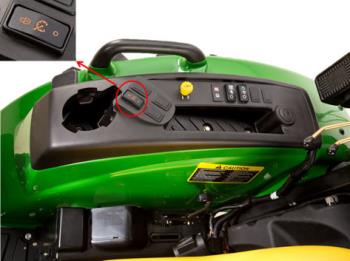 Optional cruise control on 4M Tractors
Optional cruise control on 4M Tractors

A true-speed cruise control is optional equipment on 4M Tractors with eHydro transmission. Cruise control is electronically engaged and disengaged and is located on the operator console to the right of the operator.
- Maintains desired forward speed without pressure on the foot pedal
- Cruise control is set by engaging the switch when the desired speed is reached
- A speed sensor also allows the tractor to maintain preset speed driving up and down hills
- To disengage the cruise control, either:
- Apply pressure to the turn brakes opposite the eHydro pedals
- Disengage cruise control switch
- Briefly depress the reverse control pedal
LoadMatch™ power management system
LoadMatch is a standard feature on the 4M Series Tractors.
If torque requirements increase significantly, the transmission will reduce the tractor's drive speed to compensate for the increased load on the transmission, maximizing torque to drive wheels and minimizing stalls.
Controls automatically adjust LoadMatch compensation depending on the tractor’s application. PTO applications require less engine speed fluctuation, therefore adjusting the amount of droop depending on PTO speed. This adjustment increases efficiency and optimizes engine speed and torque output based on tractor application.
While typically left on, LoadMatch can be turned off through the center console display.
MotionMatch™ system
MotionMatch, standard on the 4M Series Tractors, is adjustable through the center console display. It offers variable adjustments to either lengthen or shorten the rollout when the HST pedal is depressed or released.
Serial number break information
All model year 2016 and newer tractors with serial numbers after those listed below are equipped with LoadMatch and MotionMatch features from the factory
- 4044M: 1LV4044MCGG100594
- 4052M: 1LV4052MVGG100273
- 4066M: 1LV4066MHGG100181
For model year 2016 tractors with serial numbers before those listed above and previous model year tractors, these features are available with a machine software update.
Danfoss is a trademark of Danfoss Incorporated.
Operator station is comfortable and convenient
Addition of optional center console toolbox
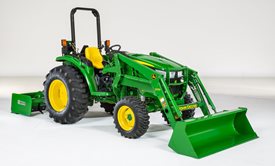 Easy entry and exit from the operator's station
Easy entry and exit from the operator's station

The operator's station is designed for easy entry and exit from the tractor.
Conveniently placed brake pedals, as well as repositioned operator controls, provide for a clean and flat platform design giving the operator plenty of legroom.
- Hood and fenders are made from impact-resistant polymer material designed to eliminate the possibility of rusting and to resist dents that can occur with metal hoods or fenders.
- The hood is painted to an automotive-like finish, providing a high-luster appearance with excellent resilience and resistance to fading from sunlight.
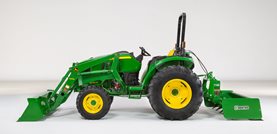 Comfortable and convenient design
Comfortable and convenient design

Key features of the operator's station include:
- Large grab handles on each fender make getting on and off the tractor easy.
- Controls are shape and color-coded for easier identification and operation.
- Optional mechanical suspension seat improves operator comfort and reduces fatigue.
- A left-side step is in base equipment to enhance access to the operator's station.
- The mechanical suspension seat gives the operator a comfortable ride. The seat flips forward for protection from the elements.
- Seat suspension is adjustable for the operator's weight and height.
- Operator weight adjustment adjusts to the operator’s weight 52 kg to 125 kg (115 lb to 275 lb).
- The seat is adjustable fore and aft for the operator’s height using the lever located under the seat.
 Retractable seat belts
Retractable seat belts

- Retractable seat belts prevent belts from becoming tangled in seat suspension and controls
Built-in safety features for operator peace of mind
Safety is designed into all 4M and 4R Series Tractors.
- Operator presence system ensures the operator is in the seat to run the tractor
- If the operator leaves the seat when front or rear power take-off (PTO) is engaged, the engine shuts down.
- For stationary PTO work, the tractor must be in neutral and the park brake fully set.
- The rollover protective structure (ROPS) is designed for operation safety
- Reflective ROPS strips for better tractor visibility
- Key switch interlock prevents bypass starting
- Visual PTO warning light alerts operator when rear PTO is running
- Placing the transmission in neutral and setting the park brake allows operator to run rear PTO safely when off the tractor seat
- Turn signal and flashing warning lights operate according to ASAE S279.10 standard
- Taillights for road transport
- Slow moving vehicle (SMV) sign for road transport
Optional iMatch™ Quick-Hitch allows for easy implement hookup
 iMatch Quick-Hitch
iMatch Quick-Hitch
 iMatch Quick-Hitch with rotary cutter hookup
iMatch Quick-Hitch with rotary cutter hookup
 iMatch Quick-Hitch (LVB25976)
iMatch Quick-Hitch (LVB25976)
 iMatch Quick-Hitch with rotary cutter hookup (LVB25976)
iMatch Quick-Hitch with rotary cutter hookup (LVB25976)
One of the greatest customer concerns involves difficulty in attaching tractor implements. John Deere has addressed this issue with the iMatch Quick-Hitch.
The iMatch Quick-Hitch provides easy hookup and a guaranteed fit for all Category 1 implements that are designed to meet the ASAE Category 1 Standard S278.6 for quick-attach hitches.
- All implements require a set of bushings in order for the attachment to fit and work properly with the iMatch Quick-Hitch. One set of bushings comes with the iMatch Quick-Hitch.
NOTE: The bushing set can be seen in the picture above. These bushings allow the hooks on the iMatch and the pins on the implement to fit together properly. All other implements (box blades, tillers, rear blades, etc.) will require a set of bushings to enlarge the pin to fit with the iMatch hooks. Bushings of different lengths can be found in the parts system or through a bushing supplier (see dimensions below).
- Upper bushing
- Inside diameter: 1.93-1.06 cm (0.76-0.77 in.)
- Outside diameter: 3.15 to 3.43 cm (1.24-1.25 in.)
- Lower bushings
- Inside diameter: 2.24 to 2.26 cm (0.88 to 0.89 in.)
- Outside diameter: 3.63 to 3.66 cm (1.43 to 1.44 in.)
Excellent serviceability reduces operational costs and improves productivity
Regular service and maintenance are essential to the performance, productivity, and longevity of the tractor.
- Easy access to regular service points minimizes service time.
- Easily removable cowl and side panels, improved hood design, and integrated maintenance position on the grille provide easy accessibility for routine maintenance.
- Tractors are equipped with extensive onboard self-diagnostic capabilities and are fully compatible with John Deere’s exclusive Service ADVISOR™ system.
- Daily service requirements are minimal and simple to accomplish. Most service interval requirements can be performed with a basic understanding of procedures and common tools.
- Improved cost of ownership
- Hydraulic oil service interval changed from 400 to 1200 hours (or 3 years) when using Hy-Gard™ products
 Removable side panels
Removable side panels
 Integrated grille maintenance position
Integrated grille maintenance position
 Removable cowl
Removable cowl
All items in the daily service schedule can be performed without the use of tools:
- Engine oil, hydraulic oil, coolant level, and the water separator can be conveniently accessed
- The engine can be easily accessed by simply raising the hood for more periodic maintenance checks
- A single-point latch mechanism and self-contained leash ensure easy hood opening and closure
NOTE: Always refer to the operator’s manual for complete maintenance and service recommendations.
Features
Attractive styling provides improved visibility and serviceability
 4R Tractor
4R Tractor

The bold styling of the 4M and 4R Tractors provide an attractive and functional appearance similar to that of the larger agricultural tractors. Benefits of this styling include:
- Easy tractor family identification
- Updated fixed grille and side panel hood design allows for optimum sealing of the cooling compartment
- Front grille slides up to an integrated maintenance position for easy battery access
- Easily removable cowl, allowing for serviceability access
- Wraparound-style halogen headlights
- Premium integrated automotive style headlight bezels
- Bold graphics
- Aggressively sloped hood design, giving a softer, smoother look and providing improved visibility
- Hybrid exhaust in base on cab tractors for clear operator visibility and safety
- At low speed and when tractor is in a filter cleaning process, exhaust will be routed through vertical exhaust outlet. In all other cases, the exhaust will be routed through the downward exhaust outlet.
- Side exhaust in base on open operator station tractors and ensures minimal heat impact to operator
The result gives the tractor a distinctive appearance and feel.
NOTE: If the tractor is equipped with an optional field-installed vertical exhaust, exhaust pipe must be removed before opening and closing the hood of the tractor.
Powerful Yanmar® diesel engine delivers plenty of power under heavy loads
 Powerful Yanmar engine
Powerful Yanmar engine
The Yanmar diesel engine has a high-torque reserve that provides plenty of power under heavy load.
This 4-cylinder engine features lower levels of exhaust emissions and reduced noise levels. It meets EPA Final Tier 4 (FT4) emission standards.
Model |
Number of |
Engine |
Aspiration |
Rated |
Gross engine |
Gross engine ps* |
PTO hp |
4 |
2.2 L |
Natural |
42.5 |
43.1 |
32.5 |
||
4052M/R |
4 |
2.1 L |
Turbocharged |
50.8 |
51.5 |
39.9 |
|
4066M/R |
4 |
2.1 L |
Turbocharged |
2600 |
65.0 |
65.9 |
52.0 |
Displacement, cu in. (L):134.25 (2.2)
*Engine hp (kW), gross SAE J1995: 51.5 (37.9) at 2600 rpm, PS
Displacement, cu in. (L):128.15 (2.1)
*Engine hp (kW), gross SAE J1995: 65.9 (48.5) at 2600 rpm, PS
Displacement, cu in. (L):128.15 (2.1)
The engine uses the latest technologies to optimize fuel economy, improve control and accuracy, and reduce environmental impact.
The common rail system (CRS) optimizes fuel economy and reduces operating costs*. High-pressure injection atomizes fuel into finer particles which burn more completely. It results in improved fuel economy and lower cost of operation.
The electronic control unit (ECU) provides optimum fuel control and accuracy. ECU monitors and controls the engine. It continuously monitors engine conditions and adjusts the fuel delivery accordingly to ensure optimum performance and emissions.
The new engine comes with an after treatment system. The system operates automatically. The exhaust filter consists of a diesel particulate filter (DPF) which captures particulate matter (PM) contained in the exhaust gas. Using a natural cleaning process, most of the PM trapped in the exhaust filter is eliminated by the heat of the exhaust stream generated by normal use. In situations of low temperature, engine speed or load factor, an active cleaning cycle is initiated. In this cleaning cycle, the exhaust gas temperature is raised by injecting additional fuel during the exhaust stroke of normal vehicle operation to the diesel oxidation catalyst (DOC).
After many hours of use, the exhaust filter may require an ash removal service.
NOTE: *As compared to engines not using CRS technology.
DPF cleaning
Depending on the load that the tractor is under, as well as ambient temperature, humidity, and engine speed, the DPF may build up with particulate matter, thus requiring cleaning. Filter cleaning is determined by one of three conditions:
- A prescribed time-based estimation of needed filter cleaning
- DOC/DPF pressure sensors
- A particulate matter buildup estimation based on load conditions
Once one of the three conditions has been met, filter cleaning will occur.
There are three different types of filter cleaning processes:
- Passive filter cleaning
- Active filter cleaning
- Parked filter cleaning
Passive filter cleaning
Passive filter cleaning occurs naturally when the engine is generating enough heat to oxidize particulate matter. This automatic process occurs continuously during normal operating conditions. No tractor icons or symbols appear on the display during passive filter cleaning.
NOTE: Passive filter cleaning requires no operator involvement, and there is no interruption to tractor operation.
Active filter cleaning
If conditions (temperature, load, or speed) for passive filter cleaning cannot be achieved, then PM is removed using active filter cleaner.
To achieve the required conditions, exhaust temperature management (ETM) manages the initiation and duration of active filter cleaning. ETM can adjust numerous engine parameters and/or inject a small quantity of fuel into the exhaust stream for a short duration. The fuel turns to vapor and chemically reacts with the catalysts in the DOC to create heat to oxidize PM.
It is important to note that at no time is the fuel in the DOC/DPF ignited, and there is no flame within the DOC/DPF.
Like passive filter cleaning, active filter cleaning requires no operator involvement, and there is no interruption to tractor operation.
Parked filter cleaning
In some instances where passive and active filter cleaning have not fully cleaned the PM from the system, a parked filter cleaning may need to take place. Most likely, the only time a parked filter cleaning will need to occur is when automatic filter cleaning has been disabled for an extended period of time and multiple warnings to engage filter cleaning were ignored or if the tractor has been used during light load conditions. Additionally, when the automatic filter cleaning process has been deliberately interrupted multiple times, or if active filter cleaning has failed numerous times due to a failed component, a parked filter cleaning may be requested. In these rare instances the operator will have to park the tractor and start the filter cleaning process.
The parked filter cleaning process needs to be activated based on usage and operation of the tractor. The process will take approximately 30 minutes. See operator’s manual for more details.
This system constantly monitors the soot level of the tractor, making sure the tractor is always in peak performance condition. This ensures high performance at all times.
NOTE: Number of hours since last regeneration and soot level percentage viewable on LCD display.
Key features of the engine are:
- Lower rated speed for 540 rpm power take-off (PTO) operation means better fuel economy, less noise and vibration, and longer overall engine life
- Cast-in-block cylinder design for good cooling and long life
- Hydraulic lifters are quieter and require no adjustment
- Heavy-duty crankshaft provides more bearing surface area for added durability
- CRS optimizes fuel economy, lowering the cost of operation
- ECU provides optimum control and accuracy
- Direct fuel injection
- Improves starting
- Injects fuel directly on top of pistons for more efficient combustion
- Develops more horsepower per gallon of fuel
- Glow plugs (cold starting aid)
- Engine oil cooler, cools engine oil for longer engine life
- Key start and shutoff eliminates fuel shutoff knob
- Electric solenoid shuts fuel supply off immediately when key is turned off
- See-through coolant recovery tank permits operator to check coolant level without removing radiator cap
- Sealed radiator compartment keeps trash and debris on outside of hood
 Dry-type air cleaner
Dry-type air cleaner

- Dry-type air cleaner with safety element and electronic air service indicator
- Electronic air restriction indicator alerts operator when air filter servicing is required
- Dual-element design for added engine protection
- Easy to service
- Standard side exhaust
- Discharges fumes away from the operator, reducing engine noise
- Improves operator visibility when using a loader or front implement
- Optional vertical exhaust
Yanmar is a trademark of Yanmar Company Limited.
PowrReverser™ transmission allows for clutchless direction changes
PowrReverser transmission allows for clutchless direction changes
 PowrReverser transmission lever
PowrReverser transmission lever
The 12/12 PowrReverser transmission is available on the 4M and 4R Tractors.
The PowrReverser transmission offers a hydraulically shifted forward-to-reverse transmission. This allows for clutchless shuttle shifting between forward and reverse with one lever for quick and easy direction change.
- PowrReverser transmission does not require the operator to use the clutch to shift between forward and reverse
The PowrReverser transmission features a hydraulically actuated wet clutch. Two multi-disk clutch packs (one forward and one reverse) are hydraulically engaged when the directional (reverser) lever is placed in either the forward or reverse position.
Each clutch pack consists of three large, 5-in. diameter clutch disks that operate in oil and are oil-cooled, allowing excellent heat dissipation and extended clutch life.
 Forward/reverse clutches
Forward/reverse clutches
- Clutch A is used for the forward operation of the tractor
- Clutch B is used for the reverse operation of the tractor
Key features of the PowrReverser transmission:
- 12 forward/12 reverse (12F/12R) speeds
- Reverser lever, located on the left side of the instrument console, allows the operator to make direction changes without clutching
- Fast shuttle shift for improved loader operation
- Dual-cone synchronizers allow for synchronized shifts between gears for on-the-go shifting with the use of the clutch
- Dual-cone synchronizers permit on-the-go, low-effort shifting between gears
- Helical-cut gears for quiet operation
 Helical-cut gears
Helical-cut gears

- Well-spaced speeds for turf, loader, and transport work
- Neutral start switch prevents tractor from starting when transmission (main range) is not in neutral
- Dual wet-disk clutches provide long clutch life
- Shifts between ranges are not synchronized
- PowrReverser transmission models have both hand and foot throttle controls
- Especially handy when using a loader
Maximize productivity with an eHydro™ transmission
The tractor is available with a three-range electronic hydrostatic (eHydro) transmission.
- Fluid under pressure transmits engine power to the drive wheels using a pump and motor
- Functions both as a clutch and transmission
- Provides high torque for startup
- Reduces powertrain shock loads
Danfoss® company supplies both the pump and motor. This ensures that the components are matched to each other, providing maximum efficiency.
The electronic hydrostatic transmission is ideally suited for jobs where productivity is a must, such as loader or mower applications.
Twin Touch™ foot controls allow the operator to select both directions of travel and speed with a touch of the toe.
Key features of the eHydro transmission:
- Infinitely variable ground speeds, in each range, allow the operator to match the speed of the tractor to the job.
- No clutching for fast and easy direction changes
- Twin Touch foot pedals for quick and easy forward/reverse operation
- Cruise control is optional equipment
- Cruise control switch is located on the right-hand console for easy access
- Cruise control is electronically engaged and disengaged, which allows for precise setting of speed
 Danfoss eHydro transmission
Danfoss eHydro transmission

Danfoss eHydro transmission is used for reliable operation. Durability features include:
- Large forged trunnion shaft with larger support bearings that reduce vibration and noise.
- Center section made from ductile iron (much stronger than grey iron used in many competitive transmissions).
- Transmission oil cooler cools transmission oil for longer transmission life.
Safety features of the eHydro transmission include:
- The tractor will start with one or both foot pedals depressed, but it will not move until both pedals first return to neutral
- Operator presence - the tractor will come to a stop if the operator leaves the seat but will not shut off unless the power take-off (PTO) is also running
Key John Deere advantage
 Twin Touch foot controls
Twin Touch foot controls

John Deere's Twin Touch foot controls offer several key advantages over competitive hydro model tractors.
- Some competitive hydrostatic tractors use a treadle pedal (toe-heel) design foot control for operation of the hydro
- Requires the operator to use both toe and heel to change direction, resulting in increased operator fatigue
Optional cruise control
 Optional cruise control on 4M Tractors
Optional cruise control on 4M Tractors

A true-speed cruise control is optional equipment on 4M Tractors with eHydro transmission. Cruise control is electronically engaged and disengaged and is located on the operator console to the right of the operator.
- Maintains desired forward speed without pressure on the foot pedal
- Cruise control is set by engaging the switch when the desired speed is reached
- A speed sensor also allows the tractor to maintain preset speed driving up and down hills
- To disengage the cruise control, either:
- Apply pressure to the turn brakes opposite the eHydro pedals
- Disengage cruise control switch
- Briefly depress the reverse control pedal
LoadMatch™ power management system
LoadMatch is a standard feature on the 4M Series Tractors.
If torque requirements increase significantly, the transmission will reduce the tractor's drive speed to compensate for the increased load on the transmission, maximizing torque to drive wheels and minimizing stalls.
Controls automatically adjust LoadMatch compensation depending on the tractor’s application. PTO applications require less engine speed fluctuation, therefore adjusting the amount of droop depending on PTO speed. This adjustment increases efficiency and optimizes engine speed and torque output based on tractor application.
While typically left on, LoadMatch can be turned off through the center console display.
MotionMatch™ system
MotionMatch, standard on the 4M Series Tractors, is adjustable through the center console display. It offers variable adjustments to either lengthen or shorten the rollout when the HST pedal is depressed or released.
Serial number break information
All model year 2016 and newer tractors with serial numbers after those listed below are equipped with LoadMatch and MotionMatch features from the factory
- 4044M: 1LV4044MCGG100594
- 4052M: 1LV4052MVGG100273
- 4066M: 1LV4066MHGG100181
For model year 2016 tractors with serial numbers before those listed above and previous model year tractors, these features are available with a machine software update.
Danfoss is a trademark of Danfoss Incorporated.
Operator station is comfortable and convenient
Addition of optional center console toolbox
 Easy entry and exit from the operator's station
Easy entry and exit from the operator's station

The operator's station is designed for easy entry and exit from the tractor.
Conveniently placed brake pedals, as well as repositioned operator controls, provide for a clean and flat platform design giving the operator plenty of legroom.
- Hood and fenders are made from impact-resistant polymer material designed to eliminate the possibility of rusting and to resist dents that can occur with metal hoods or fenders.
- The hood is painted to an automotive-like finish, providing a high-luster appearance with excellent resilience and resistance to fading from sunlight.
 Comfortable and convenient design
Comfortable and convenient design

Key features of the operator's station include:
- Large grab handles on each fender make getting on and off the tractor easy.
- Controls are shape and color-coded for easier identification and operation.
- Optional mechanical suspension seat improves operator comfort and reduces fatigue.
- A left-side step is in base equipment to enhance access to the operator's station.
- The mechanical suspension seat gives the operator a comfortable ride. The seat flips forward for protection from the elements.
- Seat suspension is adjustable for the operator's weight and height.
- Operator weight adjustment adjusts to the operator’s weight 52 kg to 125 kg (115 lb to 275 lb).
- The seat is adjustable fore and aft for the operator’s height using the lever located under the seat.
 Retractable seat belts
Retractable seat belts

- Retractable seat belts prevent belts from becoming tangled in seat suspension and controls
Built-in safety features for operator peace of mind
Safety is designed into all 4M and 4R Series Tractors.
- Operator presence system ensures the operator is in the seat to run the tractor
- If the operator leaves the seat when front or rear power take-off (PTO) is engaged, the engine shuts down.
- For stationary PTO work, the tractor must be in neutral and the park brake fully set.
- The rollover protective structure (ROPS) is designed for operation safety
- Reflective ROPS strips for better tractor visibility
- Key switch interlock prevents bypass starting
- Visual PTO warning light alerts operator when rear PTO is running
- Placing the transmission in neutral and setting the park brake allows operator to run rear PTO safely when off the tractor seat
- Turn signal and flashing warning lights operate according to ASAE S279.10 standard
- Taillights for road transport
- Slow moving vehicle (SMV) sign for road transport
Optional iMatch™ Quick-Hitch allows for easy implement hookup
 iMatch Quick-Hitch
iMatch Quick-Hitch
 iMatch Quick-Hitch with rotary cutter hookup
iMatch Quick-Hitch with rotary cutter hookup
 iMatch Quick-Hitch (LVB25976)
iMatch Quick-Hitch (LVB25976)
 iMatch Quick-Hitch with rotary cutter hookup (LVB25976)
iMatch Quick-Hitch with rotary cutter hookup (LVB25976)
One of the greatest customer concerns involves difficulty in attaching tractor implements. John Deere has addressed this issue with the iMatch Quick-Hitch.
The iMatch Quick-Hitch provides easy hookup and a guaranteed fit for all Category 1 implements that are designed to meet the ASAE Category 1 Standard S278.6 for quick-attach hitches.
- All implements require a set of bushings in order for the attachment to fit and work properly with the iMatch Quick-Hitch. One set of bushings comes with the iMatch Quick-Hitch.
NOTE: The bushing set can be seen in the picture above. These bushings allow the hooks on the iMatch and the pins on the implement to fit together properly. All other implements (box blades, tillers, rear blades, etc.) will require a set of bushings to enlarge the pin to fit with the iMatch hooks. Bushings of different lengths can be found in the parts system or through a bushing supplier (see dimensions below).
- Upper bushing
- Inside diameter: 1.93-1.06 cm (0.76-0.77 in.)
- Outside diameter: 3.15 to 3.43 cm (1.24-1.25 in.)
- Lower bushings
- Inside diameter: 2.24 to 2.26 cm (0.88 to 0.89 in.)
- Outside diameter: 3.63 to 3.66 cm (1.43 to 1.44 in.)
Excellent serviceability reduces operational costs and improves productivity
Regular service and maintenance are essential to the performance, productivity, and longevity of the tractor.
- Easy access to regular service points minimizes service time.
- Easily removable cowl and side panels, improved hood design, and integrated maintenance position on the grille provide easy accessibility for routine maintenance.
- Tractors are equipped with extensive onboard self-diagnostic capabilities and are fully compatible with John Deere’s exclusive Service ADVISOR™ system.
- Daily service requirements are minimal and simple to accomplish. Most service interval requirements can be performed with a basic understanding of procedures and common tools.
- Improved cost of ownership
- Hydraulic oil service interval changed from 400 to 1200 hours (or 3 years) when using Hy-Gard™ products
 Removable side panels
Removable side panels
 Integrated grille maintenance position
Integrated grille maintenance position
 Removable cowl
Removable cowl
All items in the daily service schedule can be performed without the use of tools:
- Engine oil, hydraulic oil, coolant level, and the water separator can be conveniently accessed
- The engine can be easily accessed by simply raising the hood for more periodic maintenance checks
- A single-point latch mechanism and self-contained leash ensure easy hood opening and closure
NOTE: Always refer to the operator’s manual for complete maintenance and service recommendations.
Features
Attractive styling provides improved visibility and serviceability
 4R Tractor
4R Tractor

The bold styling of the 4M and 4R Tractors provide an attractive and functional appearance similar to that of the larger agricultural tractors. Benefits of this styling include:
- Easy tractor family identification
- Updated fixed grille and side panel hood design allows for optimum sealing of the cooling compartment
- Front grille slides up to an integrated maintenance position for easy battery access
- Easily removable cowl, allowing for serviceability access
- Wraparound-style halogen headlights
- Premium integrated automotive style headlight bezels
- Bold graphics
- Aggressively sloped hood design, giving a softer, smoother look and providing improved visibility
- Hybrid exhaust in base on cab tractors for clear operator visibility and safety
- At low speed and when tractor is in a filter cleaning process, exhaust will be routed through vertical exhaust outlet. In all other cases, the exhaust will be routed through the downward exhaust outlet.
- Side exhaust in base on open operator station tractors and ensures minimal heat impact to operator
The result gives the tractor a distinctive appearance and feel.
NOTE: If the tractor is equipped with an optional field-installed vertical exhaust, exhaust pipe must be removed before opening and closing the hood of the tractor.
Powerful Yanmar® diesel engine delivers plenty of power under heavy loads
 Powerful Yanmar engine
Powerful Yanmar engine
The Yanmar diesel engine has a high-torque reserve that provides plenty of power under heavy load.
This 4-cylinder engine features lower levels of exhaust emissions and reduced noise levels. It meets EPA Final Tier 4 (FT4) emission standards.
Model |
Number of |
Engine |
Aspiration |
Rated |
Gross engine |
Gross engine ps* |
PTO hp |
4 |
2.2 L |
Natural |
42.5 |
43.1 |
32.5 |
||
4052M/R |
4 |
2.1 L |
Turbocharged |
50.8 |
51.5 |
39.9 |
|
4066M/R |
4 |
2.1 L |
Turbocharged |
2600 |
65.0 |
65.9 |
52.0 |
Displacement, cu in. (L):134.25 (2.2)
*Engine hp (kW), gross SAE J1995: 51.5 (37.9) at 2600 rpm, PS
Displacement, cu in. (L):128.15 (2.1)
*Engine hp (kW), gross SAE J1995: 65.9 (48.5) at 2600 rpm, PS
Displacement, cu in. (L):128.15 (2.1)
The engine uses the latest technologies to optimize fuel economy, improve control and accuracy, and reduce environmental impact.
The common rail system (CRS) optimizes fuel economy and reduces operating costs*. High-pressure injection atomizes fuel into finer particles which burn more completely. It results in improved fuel economy and lower cost of operation.
The electronic control unit (ECU) provides optimum fuel control and accuracy. ECU monitors and controls the engine. It continuously monitors engine conditions and adjusts the fuel delivery accordingly to ensure optimum performance and emissions.
The new engine comes with an after treatment system. The system operates automatically. The exhaust filter consists of a diesel particulate filter (DPF) which captures particulate matter (PM) contained in the exhaust gas. Using a natural cleaning process, most of the PM trapped in the exhaust filter is eliminated by the heat of the exhaust stream generated by normal use. In situations of low temperature, engine speed or load factor, an active cleaning cycle is initiated. In this cleaning cycle, the exhaust gas temperature is raised by injecting additional fuel during the exhaust stroke of normal vehicle operation to the diesel oxidation catalyst (DOC).
After many hours of use, the exhaust filter may require an ash removal service.
NOTE: *As compared to engines not using CRS technology.
DPF cleaning
Depending on the load that the tractor is under, as well as ambient temperature, humidity, and engine speed, the DPF may build up with particulate matter, thus requiring cleaning. Filter cleaning is determined by one of three conditions:
- A prescribed time-based estimation of needed filter cleaning
- DOC/DPF pressure sensors
- A particulate matter buildup estimation based on load conditions
Once one of the three conditions has been met, filter cleaning will occur.
There are three different types of filter cleaning processes:
- Passive filter cleaning
- Active filter cleaning
- Parked filter cleaning
Passive filter cleaning
Passive filter cleaning occurs naturally when the engine is generating enough heat to oxidize particulate matter. This automatic process occurs continuously during normal operating conditions. No tractor icons or symbols appear on the display during passive filter cleaning.
NOTE: Passive filter cleaning requires no operator involvement, and there is no interruption to tractor operation.
Active filter cleaning
If conditions (temperature, load, or speed) for passive filter cleaning cannot be achieved, then PM is removed using active filter cleaner.
To achieve the required conditions, exhaust temperature management (ETM) manages the initiation and duration of active filter cleaning. ETM can adjust numerous engine parameters and/or inject a small quantity of fuel into the exhaust stream for a short duration. The fuel turns to vapor and chemically reacts with the catalysts in the DOC to create heat to oxidize PM.
It is important to note that at no time is the fuel in the DOC/DPF ignited, and there is no flame within the DOC/DPF.
Like passive filter cleaning, active filter cleaning requires no operator involvement, and there is no interruption to tractor operation.
Parked filter cleaning
In some instances where passive and active filter cleaning have not fully cleaned the PM from the system, a parked filter cleaning may need to take place. Most likely, the only time a parked filter cleaning will need to occur is when automatic filter cleaning has been disabled for an extended period of time and multiple warnings to engage filter cleaning were ignored or if the tractor has been used during light load conditions. Additionally, when the automatic filter cleaning process has been deliberately interrupted multiple times, or if active filter cleaning has failed numerous times due to a failed component, a parked filter cleaning may be requested. In these rare instances the operator will have to park the tractor and start the filter cleaning process.
The parked filter cleaning process needs to be activated based on usage and operation of the tractor. The process will take approximately 30 minutes. See operator’s manual for more details.
This system constantly monitors the soot level of the tractor, making sure the tractor is always in peak performance condition. This ensures high performance at all times.
NOTE: Number of hours since last regeneration and soot level percentage viewable on LCD display.
Key features of the engine are:
- Lower rated speed for 540 rpm power take-off (PTO) operation means better fuel economy, less noise and vibration, and longer overall engine life
- Cast-in-block cylinder design for good cooling and long life
- Hydraulic lifters are quieter and require no adjustment
- Heavy-duty crankshaft provides more bearing surface area for added durability
- CRS optimizes fuel economy, lowering the cost of operation
- ECU provides optimum control and accuracy
- Direct fuel injection
- Improves starting
- Injects fuel directly on top of pistons for more efficient combustion
- Develops more horsepower per gallon of fuel
- Glow plugs (cold starting aid)
- Engine oil cooler, cools engine oil for longer engine life
- Key start and shutoff eliminates fuel shutoff knob
- Electric solenoid shuts fuel supply off immediately when key is turned off
- See-through coolant recovery tank permits operator to check coolant level without removing radiator cap
- Sealed radiator compartment keeps trash and debris on outside of hood
 Dry-type air cleaner
Dry-type air cleaner

- Dry-type air cleaner with safety element and electronic air service indicator
- Electronic air restriction indicator alerts operator when air filter servicing is required
- Dual-element design for added engine protection
- Easy to service
- Standard side exhaust
- Discharges fumes away from the operator, reducing engine noise
- Improves operator visibility when using a loader or front implement
- Optional vertical exhaust
Yanmar is a trademark of Yanmar Company Limited.
PowrReverser™ transmission allows for clutchless direction changes
PowrReverser transmission allows for clutchless direction changes
 PowrReverser transmission lever
PowrReverser transmission lever
The 12/12 PowrReverser transmission is available on the 4M and 4R Tractors.
The PowrReverser transmission offers a hydraulically shifted forward-to-reverse transmission. This allows for clutchless shuttle shifting between forward and reverse with one lever for quick and easy direction change.
- PowrReverser transmission does not require the operator to use the clutch to shift between forward and reverse
The PowrReverser transmission features a hydraulically actuated wet clutch. Two multi-disk clutch packs (one forward and one reverse) are hydraulically engaged when the directional (reverser) lever is placed in either the forward or reverse position.
Each clutch pack consists of three large, 5-in. diameter clutch disks that operate in oil and are oil-cooled, allowing excellent heat dissipation and extended clutch life.
 Forward/reverse clutches
Forward/reverse clutches
- Clutch A is used for the forward operation of the tractor
- Clutch B is used for the reverse operation of the tractor
Key features of the PowrReverser transmission:
- 12 forward/12 reverse (12F/12R) speeds
- Reverser lever, located on the left side of the instrument console, allows the operator to make direction changes without clutching
- Fast shuttle shift for improved loader operation
- Dual-cone synchronizers allow for synchronized shifts between gears for on-the-go shifting with the use of the clutch
- Dual-cone synchronizers permit on-the-go, low-effort shifting between gears
- Helical-cut gears for quiet operation
 Helical-cut gears
Helical-cut gears

- Well-spaced speeds for turf, loader, and transport work
- Neutral start switch prevents tractor from starting when transmission (main range) is not in neutral
- Dual wet-disk clutches provide long clutch life
- Shifts between ranges are not synchronized
- PowrReverser transmission models have both hand and foot throttle controls
- Especially handy when using a loader
Maximize productivity with an eHydro™ transmission
The tractor is available with a three-range electronic hydrostatic (eHydro) transmission.
- Fluid under pressure transmits engine power to the drive wheels using a pump and motor
- Functions both as a clutch and transmission
- Provides high torque for startup
- Reduces powertrain shock loads
Danfoss® company supplies both the pump and motor. This ensures that the components are matched to each other, providing maximum efficiency.
The electronic hydrostatic transmission is ideally suited for jobs where productivity is a must, such as loader or mower applications.
Twin Touch™ foot controls allow the operator to select both directions of travel and speed with a touch of the toe.
Key features of the eHydro transmission:
- Infinitely variable ground speeds, in each range, allow the operator to match the speed of the tractor to the job.
- No clutching for fast and easy direction changes
- Twin Touch foot pedals for quick and easy forward/reverse operation
- Cruise control is optional equipment
- Cruise control switch is located on the right-hand console for easy access
- Cruise control is electronically engaged and disengaged, which allows for precise setting of speed
 Danfoss eHydro transmission
Danfoss eHydro transmission

Danfoss eHydro transmission is used for reliable operation. Durability features include:
- Large forged trunnion shaft with larger support bearings that reduce vibration and noise.
- Center section made from ductile iron (much stronger than grey iron used in many competitive transmissions).
- Transmission oil cooler cools transmission oil for longer transmission life.
Safety features of the eHydro transmission include:
- The tractor will start with one or both foot pedals depressed, but it will not move until both pedals first return to neutral
- Operator presence - the tractor will come to a stop if the operator leaves the seat but will not shut off unless the power take-off (PTO) is also running
Key John Deere advantage
 Twin Touch foot controls
Twin Touch foot controls

John Deere's Twin Touch foot controls offer several key advantages over competitive hydro model tractors.
- Some competitive hydrostatic tractors use a treadle pedal (toe-heel) design foot control for operation of the hydro
- Requires the operator to use both toe and heel to change direction, resulting in increased operator fatigue
Optional cruise control
 Optional cruise control on 4M Tractors
Optional cruise control on 4M Tractors

A true-speed cruise control is optional equipment on 4M Tractors with eHydro transmission. Cruise control is electronically engaged and disengaged and is located on the operator console to the right of the operator.
- Maintains desired forward speed without pressure on the foot pedal
- Cruise control is set by engaging the switch when the desired speed is reached
- A speed sensor also allows the tractor to maintain preset speed driving up and down hills
- To disengage the cruise control, either:
- Apply pressure to the turn brakes opposite the eHydro pedals
- Disengage cruise control switch
- Briefly depress the reverse control pedal
LoadMatch™ power management system
LoadMatch is a standard feature on the 4M Series Tractors.
If torque requirements increase significantly, the transmission will reduce the tractor's drive speed to compensate for the increased load on the transmission, maximizing torque to drive wheels and minimizing stalls.
Controls automatically adjust LoadMatch compensation depending on the tractor’s application. PTO applications require less engine speed fluctuation, therefore adjusting the amount of droop depending on PTO speed. This adjustment increases efficiency and optimizes engine speed and torque output based on tractor application.
While typically left on, LoadMatch can be turned off through the center console display.
MotionMatch™ system
MotionMatch, standard on the 4M Series Tractors, is adjustable through the center console display. It offers variable adjustments to either lengthen or shorten the rollout when the HST pedal is depressed or released.
Serial number break information
All model year 2016 and newer tractors with serial numbers after those listed below are equipped with LoadMatch and MotionMatch features from the factory
- 4044M: 1LV4044MCGG100594
- 4052M: 1LV4052MVGG100273
- 4066M: 1LV4066MHGG100181
For model year 2016 tractors with serial numbers before those listed above and previous model year tractors, these features are available with a machine software update.
Danfoss is a trademark of Danfoss Incorporated.
Operator station is comfortable and convenient
Addition of optional center console toolbox
 Easy entry and exit from the operator's station
Easy entry and exit from the operator's station

The operator's station is designed for easy entry and exit from the tractor.
Conveniently placed brake pedals, as well as repositioned operator controls, provide for a clean and flat platform design giving the operator plenty of legroom.
- Hood and fenders are made from impact-resistant polymer material designed to eliminate the possibility of rusting and to resist dents that can occur with metal hoods or fenders.
- The hood is painted to an automotive-like finish, providing a high-luster appearance with excellent resilience and resistance to fading from sunlight.
 Comfortable and convenient design
Comfortable and convenient design

Key features of the operator's station include:
- Large grab handles on each fender make getting on and off the tractor easy.
- Controls are shape and color-coded for easier identification and operation.
- Optional mechanical suspension seat improves operator comfort and reduces fatigue.
- A left-side step is in base equipment to enhance access to the operator's station.
- The mechanical suspension seat gives the operator a comfortable ride. The seat flips forward for protection from the elements.
- Seat suspension is adjustable for the operator's weight and height.
- Operator weight adjustment adjusts to the operator’s weight 52 kg to 125 kg (115 lb to 275 lb).
- The seat is adjustable fore and aft for the operator’s height using the lever located under the seat.
 Retractable seat belts
Retractable seat belts

- Retractable seat belts prevent belts from becoming tangled in seat suspension and controls
Built-in safety features for operator peace of mind
Safety is designed into all 4M and 4R Series Tractors.
- Operator presence system ensures the operator is in the seat to run the tractor
- If the operator leaves the seat when front or rear power take-off (PTO) is engaged, the engine shuts down.
- For stationary PTO work, the tractor must be in neutral and the park brake fully set.
- The rollover protective structure (ROPS) is designed for operation safety
- Reflective ROPS strips for better tractor visibility
- Key switch interlock prevents bypass starting
- Visual PTO warning light alerts operator when rear PTO is running
- Placing the transmission in neutral and setting the park brake allows operator to run rear PTO safely when off the tractor seat
- Turn signal and flashing warning lights operate according to ASAE S279.10 standard
- Taillights for road transport
- Slow moving vehicle (SMV) sign for road transport
Optional iMatch™ Quick-Hitch allows for easy implement hookup
 iMatch Quick-Hitch
iMatch Quick-Hitch
 iMatch Quick-Hitch with rotary cutter hookup
iMatch Quick-Hitch with rotary cutter hookup
 iMatch Quick-Hitch (LVB25976)
iMatch Quick-Hitch (LVB25976)
 iMatch Quick-Hitch with rotary cutter hookup (LVB25976)
iMatch Quick-Hitch with rotary cutter hookup (LVB25976)
One of the greatest customer concerns involves difficulty in attaching tractor implements. John Deere has addressed this issue with the iMatch Quick-Hitch.
The iMatch Quick-Hitch provides easy hookup and a guaranteed fit for all Category 1 implements that are designed to meet the ASAE Category 1 Standard S278.6 for quick-attach hitches.
- All implements require a set of bushings in order for the attachment to fit and work properly with the iMatch Quick-Hitch. One set of bushings comes with the iMatch Quick-Hitch.
NOTE: The bushing set can be seen in the picture above. These bushings allow the hooks on the iMatch and the pins on the implement to fit together properly. All other implements (box blades, tillers, rear blades, etc.) will require a set of bushings to enlarge the pin to fit with the iMatch hooks. Bushings of different lengths can be found in the parts system or through a bushing supplier (see dimensions below).
- Upper bushing
- Inside diameter: 1.93-1.06 cm (0.76-0.77 in.)
- Outside diameter: 3.15 to 3.43 cm (1.24-1.25 in.)
- Lower bushings
- Inside diameter: 2.24 to 2.26 cm (0.88 to 0.89 in.)
- Outside diameter: 3.63 to 3.66 cm (1.43 to 1.44 in.)
Excellent serviceability reduces operational costs and improves productivity
Regular service and maintenance are essential to the performance, productivity, and longevity of the tractor.
- Easy access to regular service points minimizes service time.
- Easily removable cowl and side panels, improved hood design, and integrated maintenance position on the grille provide easy accessibility for routine maintenance.
- Tractors are equipped with extensive onboard self-diagnostic capabilities and are fully compatible with John Deere’s exclusive Service ADVISOR™ system.
- Daily service requirements are minimal and simple to accomplish. Most service interval requirements can be performed with a basic understanding of procedures and common tools.
- Improved cost of ownership
- Hydraulic oil service interval changed from 400 to 1200 hours (or 3 years) when using Hy-Gard™ products
 Removable side panels
Removable side panels
 Integrated grille maintenance position
Integrated grille maintenance position
 Removable cowl
Removable cowl
All items in the daily service schedule can be performed without the use of tools:
- Engine oil, hydraulic oil, coolant level, and the water separator can be conveniently accessed
- The engine can be easily accessed by simply raising the hood for more periodic maintenance checks
- A single-point latch mechanism and self-contained leash ensure easy hood opening and closure
NOTE: Always refer to the operator’s manual for complete maintenance and service recommendations.
Features
Powerful, diesel engine delivers plenty of power under heavy loads

3025E
The 1.642-L (100.2 cu in.) displacement, liquid-cooled 3TNV88F-EPJT1 Yanmar® diesel engine provides 18. kW (24.4 hp) to the 3025E.
Model |
Number of |
Engine |
Rated rpm |
Gross engine hp* |
Gross engine ps* |
PTO hp |
3025E |
3 |
1.642 L (100.2 cu in.) |
2400 |
18.2 kW (24.4 hp) |
24.7 |
14.4 kW (19.4 hp) |
*Engine kW (hp), gross SAE J1995: 18.2 (24.4) at 2400 rpm, PS
Displacement, L (cu in.): 1.642 (100.2)
3032E
The 1.642-L (100.2 cu in.) displacement, liquid-cooled 3TNV88C-NJT Yanmar diesel engine provides 22.9 kW (30.7 hp) to the 3032E.
Model |
Number of |
Engine |
Rated rpm |
Gross engine hp* |
Gross engine ps* |
PTO hp |
3032E |
3 |
1.642 L (100.2 cu in.) |
2500 |
22.9 kW (30.7 hp) |
31.2 |
18.6 kW (25 hp) |
*Engine kW (hp), gross SAE J1995: 22.9 (30.7) at 2500 rpm, PS
Displacement, L (cu in): 1.642 (100.2)
3038E
The 1.568-L (95.68 cu in.) displacement, turbocharged, liquid-cooled 3TNV86T-NJT Yanmar diesel engine provides 27.4 kW (36.7 hp) to the 3038E.
Model |
Number of |
Engine |
Rated rpm |
Gross engine hp* |
Gross engine ps* |
PTO hp |
3038E |
3 |
1.568 L (95.68 cu in.) |
2500 |
27.4 kW (36.7 hp) |
37.3 |
22.4 kW (30 hp) |
*Engine kW (hp), gross SAE J1995: 27.4 (36.7) at 2500 rpm, PS
Displacement, L (cu in.): 1.568 (95.68)
The engine uses the latest technologies to optimize fuel economy, improve control and accuracy, and reduce environmental impact. The common rail system (CRS) optimizes fuel economy and reduces operating costs*. High-pressure injection atomizes fuel into finer particles which burn more completely. It results in improved fuel economy and a lower cost of operation.
The electronic control unit (ECU) provides optimum fuel control and accuracy. ECU monitors and controls the engine. It continuously monitors engine conditions and adjusts the fuel delivery accordingly to ensure optimum performance and emissions.
The engine comes with an after-treatment system. The system operates automatically. The exhaust filter consists of a diesel particulate filter (DPF) which captures particulate matter (PM) contained in the exhaust gas. Using a natural cleaning process, most of the PM trapped in the exhaust filter is eliminated by the heat of the exhaust stream generated by normal use. In situations of low temperature, engine speed, or load factor, an active cleaning cycle is initiated. In this cleaning cycle, the exhaust gas temperature is raised by injecting additional fuel during the exhaust stroke of normal vehicle operation to the diesel oxidation catalyst (DOC).
After many hours of use, the exhaust filter may require an ash removal service.
*NOTE: As compared to engines not using CRS technology.
DPF cleaning
Depending on the load that the tractor is under, as well as ambient temperature, humidity, and engine speed, the DPF may build up with particulate matter, thus requiring cleaning. Filter cleaning is determined by one of three factors:
- A prescribed time-based estimation of needed filter cleaning
- DOC/DPF pressure sensors
- A particulate matter buildup estimation based on load conditions
Once one of the three conditions has been met, filter cleaning will occur.
There are three different types of filter cleaning processes:
- Passive filter cleaning
- Active filter cleaning
- Parked filter cleaning
Passive filter cleaning
Passive filter cleaning occurs naturally when the engine is generating enough heat to oxidize particulate matter. This automatic process occurs continuously during normal operating conditions. No tractor icons or symbols appear on the display during passive filter cleaning.
NOTE: Passive filter cleaning requires no operator involvement, and there is no interruption to tractor operation.
Active filter cleaning
If conditions (temperature, load, or speed) for passive filter cleaning cannot be achieved, then PM is removed using active filter cleaner.
To achieve the required conditions, exhaust temperature management (ETM) manages the initiation and duration of active filter cleaning. ETM can adjust numerous engine parameters and/or inject a small quantity of fuel into the exhaust stream for a short duration. The fuel turns to vapor and chemically reacts with the catalysts in the DOC to create heat to oxidize the PM.
It is important to note that at no time is the fuel in the DOC/DPF ignited, and there is no flame within the DOC/DPF.
Like passive filter cleaning, active filter cleaning requires no operator involvement, and there is no interruption to tractor operation.
Parked filter cleaning
In some instances where passive and active filter cleaning have not fully cleaned the PM from the system, a parked filter cleaning may need to take place. In general, the only time a parked filter cleaning will need to occur is when automatic filter cleaning has been disabled for an extended period of time and multiple warnings to engage filter cleaning were ignored or if the tractor has been used during light load conditions. Additionally, when the automatic filter cleaning process has been deliberately interrupted multiple times, or if active filter cleaning has failed numerous times due to a failed component, a parked filter cleaning may be requested. In these rare instances the operator will have to park the tractor and start the filter cleaning process.
The parked filter cleaning process needs to be activated based on usage and operation of the tractor. The process will take approximately 30 minutes. See the operator's manual for more details.
This system constantly monitors the soot level of the tractor; making sure the tractor is always in peak performance condition. This ensures high performance at all times.
NOTE: Number of hours since last regeneration and soot level percentage are viewable on LCD display.
Key features of the engine are:
- Economical cast-in-block cylinder design for good cooling and long life
- Direct fuel injection
- Improves starting
- Injects fuel directly on top of pistons for more efficient combustion
- Develops more horsepower per liter (gallon) of fuel than indirect injection engines
- Aluminum alloy pistons are lightweight to reduce connecting rod bearing loads and provide good heat transfer characteristics
- Design permits tighter tolerances and neutralizes expansion of the piston, which reduces blow-by and noise from piston slap
- Top rings are higher on the piston and a thinner head gasket is used to greatly reduce the volume of unburned waste gases and increase combustion efficiency
- Timing gears and injector drive gears have a helical profile to reduce engine noise
- Auto-bleed fuel system
- There is no need to prime the system if the tractor runs out of fuel
- The system will self-prime the injection pump, lines, and injectors, providing fast fuel recovery for easier starting
- High-capacity lubrication system provides filtered oil, under pressure, to all engine bearings for long life
- Key start and shutoff eliminates fuel shutoff knob
- Electric solenoid shuts fuel supply off immediately when key is turned off, which replaces the need to pull a fuel shutoff lever like many older tractors
- Fuel filter with replaceable element
- Water separator with additional replaceable filter element
- See-through coolant recovery tank permits operator to check coolant level without removing radiator cap
 Dry-type air cleaner
Dry-type air cleaner

- Dry-type air cleaner with safety element
- Dual element design for added engine protection
- Easy to service
- Hood can be easily opened without tools for full access to the engine
- Easy access to engine check and fill points on the right-hand side of the tractor by removing the side panels.
Yanmar is a trademark of Yanmar Company Limited.
Easy-to-use hydrostatic transmission (HST) increases tractor performance
The 3E Tractors are available with a two-range hydrostatic transmission (HST) incorporated in a die-cast aluminum transmission case. Fluid under pressure transmits engine power to the drive wheels via a closed-loop pump and motor arrangement. Infinite ground speeds allow the operator to match the speed of the tractor to the job.
- No clutching for fast and easy direction changes
- Twin Touch™ foot pedals for quick and easy forward/reverse operation
- Transmission oil cooler cools transmission oil for longer transmission life
Safety features of the HST include:
-
The tractor will only start with the range lever in neutral
-
The engine will shut off if the operator leaves the seat unless the range lever is in neutral
-
The engine will shut off if the operator leaves the seat and the power take-off (PTO) is engaged
Twin Touch™ foot controls
 Twin Touch foot controls
Twin Touch foot controls
Key John Deere advantage - John Deere's Twin Touch foot controls offer several key advantages over competitive HST models tractors.
-
Some competitive hydrostatic tractors use a treadle pedal (toe-heel) design foot control for operation of the HST
-
Requires the operator to use both toe and heel to change direction, resulting in increased operator fatigue
-
The Twin Touch configuration also makes it easier to "inch" the tractor forward or rearward (i.e. when attaching to implements)
-
Optional cruise control
 Optional cruise control
Optional cruise control
The 3E Series Tractors can be outfitted with an optional cruise control switch that is installed on the right-hand control console. This gives operators the ability to keep a constant speed when in transportation, field mowing, or other applications where extended use of the transmission is needed. This kit is very quick and easy to install for those who desire this feature.
Integrated hydrostatic pump and motor
- Sauer-Danfoss® company provides the integrated pump and motor; this assures that the components are matched to each other, providing maximum efficiency
- Reduces powertrain shock loads
- Provides strength and durability needed for operating such attachments as loaders
- One reservoir (with one check point and fill point) for the transmission, differential, and hydraulic system speeds up daily maintenance
- Mechanically actuated by Twin Touch foot pedals allow selecting both directions of travel and speed with the touch of a toe
Transmission reservoir fluid checkpoint
 Transmission reservoir fluid checkpoint (A)
Transmission reservoir fluid checkpoint (A)

- Easy-to-reach transmission fluid dipstick allows for frequent checks of the transmission fluid level
Transmission fill point
 Transmission fill point
Transmission fill point

-
Easy-to-reach transmission fill point (A) located on top of rear axles on the right-hand side.
Integrated brake and differential lock pedal
 Integrated brake and differential lock pedal
Integrated brake and differential lock pedal
-
Foot-actuated differential lock is integrated into the brake pedal to simplify operator controls; the differential lock is included as base equipment to assist traction in tough spots
-
Press the brake pedal down half way to engage the differential lock that locks the rear axle for improved traction in tough spots
Sauer-Danfoss is a trademark of Sauer-Danfoss Incorporated.
Clean and simple operator station is comfortable and convenient
 Clean and simple operator's station
Clean and simple operator's station
An uncluttered design gives operators of all sizes plenty of room to be comfortable. Color-coded controls are located on either side of the operator.
-
Hydrostatic transmission (HST) and brake pedals are designed and located for maximum comfort and ease of use.
-
Contoured, comfortable seat enhances operator comfort.
-
Seat position adjusts fore and aft
-
Seat flips forward for protection from the elements.
-
-
Flat operator platform provides for easy entry to/exit from the tractor.
-
Folding Roll-Gard™ rollover protective structure (ROPS) and retractable seat belt increase operator safety.
Operator presence system:
-
If the operator leaves the seat when the tractor is in gear, the engine shuts down
-
If the operator leaves the seat when the power take-off (PTO) is engaged, the engine shuts down
Left-side step
 Left-side step for easy entry/exit
Left-side step for easy entry/exit

-
The left-side step allows for easy access on and off the tractor.
-
Foot platform has a non-skid surface for sure footing.
Seat

The thick, soft padding on this seat provides a smooth and comfortable ride.
- Seat flips forward for protection from the elements.
- Adjustable using the fore and aft lever located under the seat, the seat slides on ramped rails to provide comfortable access to all controls.
Instrumentation
 Instrument panel
Instrument panel
Easy-to-read instrument panel includes the following:
- Tachometer
- Low oil pressure indicator light
- Battery discharge indicator light
- PTO engagement indicator light
- Signal/hazard lamp indicator lights
- Multi-function liquid crystal display (LCD) display (hours, filter cleaning information, etc.)
- Filter cleaning status indicator light
Fuel gauge
 Fuel gauge
Fuel gauge
All 3E Series Tractors come standard with a fuel gauge that is easy to read from the operator's station, to ensure operators do not run out of fuel.
Safety
Operator presence switch (OPS) in seat:
-
OPS requires the operator to be in the seat to operate the transmission or PTO.
-
ROPS is designed to meet or exceed American Society of Agricultural and Biological Engineers (ASABE) safety standards.
-
Reflective ROPS strips for better tractor visibility.
-
Seat belts are in base equipment on all John Deere compact utility tractors.
-
Key switch interlock prevents bypass starting.
-
Visual PTO warning light on the instrument panel alerts the operator when the PTO is running.
-
Turn signal and flashing warning lights operate according to ASABE standards.
-
Slow-moving vehicle (SMV) sign is provided for road transport.
Park brake
 Park brake
Park brake

-
Automotive hand-style park brake for easy on/off.
-
Instrument panel has an indicator light for the park brake.
2-post Roll-Gard ROPS
 Roll-Gard ROPS
Roll-Gard ROPS
3E Series Tractors are equipped with Roll-Gard ROPS. These folding ROPS meet the ASABE standards for compact utility tractors.
- Overall height is 244.3 cm (96.2 in.) with R3 tires, 242.1 cm (95.3 in.) with R4 tires, 244.6 cm (96.3 in.) with larger R4 tires, and 244.9 cm (96.4 in.) with R1 tires. With the Roll-Gard ROPS folded down, producers can easily to get their tractor into a garage with a standard 2.1-m (7-ft) garage door.
NOTE: The use of seat belts is recommended at all times when operating the 3E Series Tractor with folding ROPS.
An optional canopy is available to help protect the operator from the elements.
Optional two-spool rear selective control valve (SCV) for superior implement performance

3E Series Tractors can be equipped with a field-installed rear hydraulic remote kit, providing two additional hydraulic spools on the back of the tractor. This kit can be field installed on a tractor with a loader or without a loader.
The functions are completely separate from the loader. These rear remotes can be hooked up to a wide variety of implements and attachments such as follows:
- Hydraulically angled blade
- Hydraulically controlled chute/spout on a 3-point hitch-mounted snow blower
- Hydraulic scarifiers on a box blade
- Many other hydraulic rear attachments
This versatile kit gives 3E Series Tractor operators the options they desire for putting their tractors into a wide range of tasks.
The first spool is equipped with a float position, giving the operator the ability to contour the landscape and improve the final grade with certain implements.
NOTE: Neither of the spools in this kit are equipped with a detent position; therefore, they should not be hooked up to anything with a motor, as the valve was not designed to be run open. The kit is designed for momentary, on-demand hydraulic flow such as moving a cylinder.
The approximate installation time is 1 hour to 1.5 hours.
Optional iMatch™ Quick-Hitch feature allows for easy implement hookup
 iMatch Quick-Hitch
iMatch Quick-Hitch
 iMatch Quick-Hitch with rotary cutter hookup
iMatch Quick-Hitch with rotary cutter hookup
 iMatch Quick-Hitch (LVB25976)
iMatch Quick-Hitch (LVB25976)
 iMatch Quick-Hitch with rotary cutter hookup (LVB25976)
iMatch Quick-Hitch with rotary cutter hookup (LVB25976)
One of the greatest operator concerns involves difficulty in attaching tractor implements. John Deere has addressed this issue with the iMatch Quick-Hitch.
The iMatch Quick-Hitch provides easy hookup and a guaranteed fit for all Category 1 implements that are designed to meet the American Society of Agricultural and Biological Engineers (ASABE) Category 1 Standard S278.6 for quick-attach hitches.
- All implements require a set of bushings in order for the attachment to fit and work properly with the iMatch Quick-Hitch. One set of bushings comes with the iMatch Quick-Hitch.
NOTE: The bushing set can be seen in the picture above. These bushings allow the hooks on the iMatch and the pins on the implement to fit together properly. All other implements (box blades, tillers, rear blades, etc.) will require a set of bushings to enlarge the pin to fit with the iMatch hooks. Bushings of different lengths can be found in the parts system or through a bushing supplier (see dimensions below).
- Upper bushing
- Inside diameter: 1.93-1.95 cm (0.76-0.77 in.)
- Outside diameter: 3.15-3.18 cm (1.24-1.25 in.)
- Lower bushings
- Inside diameter: 2.24-2.26 cm (0.88 to 0.89 in.)
- Outside diameter: 3.63-3.66 cm (1.43 to 1.44 in.)
Excellent serviceability reduces operational costs and improves productivity
Regular service and maintenance are essential to the performance, productivity, and longevity of the tractor.
- Easy access to most regular service points minimizes service time
- Four quarter turn fasteners allow operators to easily remove the engine side panels without tools to access the engine compartment

- Tractors are equipped with extensive onboard self-diagnostic capabilities and are fully compatible with the John Deere-exclusive Service ADVISOR™ system
- Hydraulic oil service interval increased to 1200 hours when using Hy-Gard™ products
- Hydraulic oil filter will need to be changed every 400 hours
- Fuel tank is located on the rear of the tractor to allow for easy access when fueling

- Gas-lift hood support eliminates the need for a mechanical prop rod.

- Daily service requirements are minimal and simple to accomplish. Most service interval requirements can be performed with a basic understanding of procedures and common tools
 Removable side panels (previous model shown)
Removable side panels (previous model shown)
All items in the daily service schedule can be performed without the use of tools:
- Engine oil, hydraulic oil, coolant level, and the water separator can be conveniently accessed
- The engine can be easily accessed by simply raising the hood for more periodic maintenance checks
NOTE: Always refer to the operator’s manual for complete maintenance and service recommendations.
Features
Powerful, diesel engine delivers plenty of power under heavy loads

3025E
The 1.642-L (100.2 cu in.) displacement, liquid-cooled 3TNV88F-EPJT1 Yanmar® diesel engine provides 18. kW (24.4 hp) to the 3025E.
Model |
Number of |
Engine |
Rated rpm |
Gross engine hp* |
Gross engine ps* |
PTO hp |
3025E |
3 |
1.642 L (100.2 cu in.) |
2400 |
18.2 kW (24.4 hp) |
24.7 |
14.4 kW (19.4 hp) |
*Engine kW (hp), gross SAE J1995: 18.2 (24.4) at 2400 rpm, PS
Displacement, L (cu in.): 1.642 (100.2)
3032E
The 1.642-L (100.2 cu in.) displacement, liquid-cooled 3TNV88C-NJT Yanmar diesel engine provides 22.9 kW (30.7 hp) to the 3032E.
Model |
Number of |
Engine |
Rated rpm |
Gross engine hp* |
Gross engine ps* |
PTO hp |
3032E |
3 |
1.642 L (100.2 cu in.) |
2500 |
22.9 kW (30.7 hp) |
31.2 |
18.6 kW (25 hp) |
*Engine kW (hp), gross SAE J1995: 22.9 (30.7) at 2500 rpm, PS
Displacement, L (cu in): 1.642 (100.2)
3038E
The 1.568-L (95.68 cu in.) displacement, turbocharged, liquid-cooled 3TNV86T-NJT Yanmar diesel engine provides 27.4 kW (36.7 hp) to the 3038E.
Model |
Number of |
Engine |
Rated rpm |
Gross engine hp* |
Gross engine ps* |
PTO hp |
3038E |
3 |
1.568 L (95.68 cu in.) |
2500 |
27.4 kW (36.7 hp) |
37.3 |
22.4 kW (30 hp) |
*Engine kW (hp), gross SAE J1995: 27.4 (36.7) at 2500 rpm, PS
Displacement, L (cu in.): 1.568 (95.68)
The engine uses the latest technologies to optimize fuel economy, improve control and accuracy, and reduce environmental impact. The common rail system (CRS) optimizes fuel economy and reduces operating costs*. High-pressure injection atomizes fuel into finer particles which burn more completely. It results in improved fuel economy and a lower cost of operation.
The electronic control unit (ECU) provides optimum fuel control and accuracy. ECU monitors and controls the engine. It continuously monitors engine conditions and adjusts the fuel delivery accordingly to ensure optimum performance and emissions.
The engine comes with an after-treatment system. The system operates automatically. The exhaust filter consists of a diesel particulate filter (DPF) which captures particulate matter (PM) contained in the exhaust gas. Using a natural cleaning process, most of the PM trapped in the exhaust filter is eliminated by the heat of the exhaust stream generated by normal use. In situations of low temperature, engine speed, or load factor, an active cleaning cycle is initiated. In this cleaning cycle, the exhaust gas temperature is raised by injecting additional fuel during the exhaust stroke of normal vehicle operation to the diesel oxidation catalyst (DOC).
After many hours of use, the exhaust filter may require an ash removal service.
*NOTE: As compared to engines not using CRS technology.
DPF cleaning
Depending on the load that the tractor is under, as well as ambient temperature, humidity, and engine speed, the DPF may build up with particulate matter, thus requiring cleaning. Filter cleaning is determined by one of three factors:
- A prescribed time-based estimation of needed filter cleaning
- DOC/DPF pressure sensors
- A particulate matter buildup estimation based on load conditions
Once one of the three conditions has been met, filter cleaning will occur.
There are three different types of filter cleaning processes:
- Passive filter cleaning
- Active filter cleaning
- Parked filter cleaning
Passive filter cleaning
Passive filter cleaning occurs naturally when the engine is generating enough heat to oxidize particulate matter. This automatic process occurs continuously during normal operating conditions. No tractor icons or symbols appear on the display during passive filter cleaning.
NOTE: Passive filter cleaning requires no operator involvement, and there is no interruption to tractor operation.
Active filter cleaning
If conditions (temperature, load, or speed) for passive filter cleaning cannot be achieved, then PM is removed using active filter cleaner.
To achieve the required conditions, exhaust temperature management (ETM) manages the initiation and duration of active filter cleaning. ETM can adjust numerous engine parameters and/or inject a small quantity of fuel into the exhaust stream for a short duration. The fuel turns to vapor and chemically reacts with the catalysts in the DOC to create heat to oxidize the PM.
It is important to note that at no time is the fuel in the DOC/DPF ignited, and there is no flame within the DOC/DPF.
Like passive filter cleaning, active filter cleaning requires no operator involvement, and there is no interruption to tractor operation.
Parked filter cleaning
In some instances where passive and active filter cleaning have not fully cleaned the PM from the system, a parked filter cleaning may need to take place. In general, the only time a parked filter cleaning will need to occur is when automatic filter cleaning has been disabled for an extended period of time and multiple warnings to engage filter cleaning were ignored or if the tractor has been used during light load conditions. Additionally, when the automatic filter cleaning process has been deliberately interrupted multiple times, or if active filter cleaning has failed numerous times due to a failed component, a parked filter cleaning may be requested. In these rare instances the operator will have to park the tractor and start the filter cleaning process.
The parked filter cleaning process needs to be activated based on usage and operation of the tractor. The process will take approximately 30 minutes. See the operator's manual for more details.
This system constantly monitors the soot level of the tractor; making sure the tractor is always in peak performance condition. This ensures high performance at all times.
NOTE: Number of hours since last regeneration and soot level percentage are viewable on LCD display.
 Dry-type air cleaner
Dry-type air cleaner

- Dry-type air cleaner with safety element
- Dual element design for added engine protection
- Easy to service
- Hood can be easily opened without tools for full access to the engine
- Easy access to engine check and fill points on the right-hand side of the tractor by removing the side panels.
Yanmar is a trademark of Yanmar Company Limited.
Key features of the engine are:
- Economical cast-in-block cylinder design for good cooling and long life
- Direct fuel injection
- Improves starting
- Injects fuel directly on top of pistons for more efficient combustion
- Develops more horsepower per liter (gallon) of fuel than indirect injection engines
- Aluminum alloy pistons are lightweight to reduce connecting rod bearing loads and provide good heat transfer characteristics
- Design permits tighter tolerances and neutralizes expansion of the piston, which reduces blow-by and noise from piston slap
- Top rings are higher on the piston and a thinner head gasket is used to greatly reduce the volume of unburned waste gases and increase combustion efficiency
- Timing gears and injector drive gears have a helical profile to reduce engine noise
- Auto-bleed fuel system
- There is no need to prime the system if the tractor runs out of fuel
- The system will self-prime the injection pump, lines, and injectors, providing fast fuel recovery for easier starting
- High-capacity lubrication system provides filtered oil, under pressure, to all engine bearings for long life
- Key start and shutoff eliminates fuel shutoff knob
- Electric solenoid shuts fuel supply off immediately when key is turned off, which replaces the need to pull a fuel shutoff lever like many older tractors
- Fuel filter with replaceable element
- Water separator with additional replaceable filter element
- See-through coolant recovery tank permits operator to check coolant level without removing radiator cap
Easy-to-use hydrostatic transmission (HST) increases tractor performance
The 3E Tractors are available with a two-range hydrostatic transmission (HST) incorporated in a die-cast aluminum transmission case. Fluid under pressure transmits engine power to the drive wheels via a closed-loop pump and motor arrangement. Infinite ground speeds allow the operator to match the speed of the tractor to the job.
- No clutching for fast and easy direction changes
- Twin Touch™ foot pedals for quick and easy forward/reverse operation
- Transmission oil cooler cools transmission oil for longer transmission life
Safety features of the HST include:
-
The tractor will only start with the range lever in neutral
-
The engine will shut off if the operator leaves the seat unless the range lever is in neutral
-
The engine will shut off if the operator leaves the seat and the power take-off (PTO) is engaged
Twin Touch™ foot controls
 Twin Touch foot controls
Twin Touch foot controls
Key John Deere advantage - John Deere's Twin Touch foot controls offer several key advantages over competitive HST models tractors.
-
Some competitive hydrostatic tractors use a treadle pedal (toe-heel) design foot control for operation of the HST
-
Requires the operator to use both toe and heel to change direction, resulting in increased operator fatigue
-
The Twin Touch configuration also makes it easier to "inch" the tractor forward or rearward (i.e. when attaching to implements)
-
Optional cruise control
 Optional cruise control
Optional cruise control
The 3E Series Tractors can be outfitted with an optional cruise control switch that is installed on the right-hand control console. This gives operators the ability to keep a constant speed when in transportation, field mowing, or other applications where extended use of the transmission is needed. This kit is very quick and easy to install for those who desire this feature.
Integrated hydrostatic pump and motor
- Sauer-Danfoss® company provides the integrated pump and motor; this assures that the components are matched to each other, providing maximum efficiency
- Reduces powertrain shock loads
- Provides strength and durability needed for operating such attachments as loaders
- One reservoir (with one check point and fill point) for the transmission, differential, and hydraulic system speeds up daily maintenance
- Mechanically actuated by Twin Touch foot pedals allow selecting both directions of travel and speed with the touch of a toe
Transmission reservoir fluid checkpoint
 Transmission reservoir fluid checkpoint (A)
Transmission reservoir fluid checkpoint (A)

- Easy-to-reach transmission fluid dipstick allows for frequent checks of the transmission fluid level
Transmission fill point
 Transmission fill point
Transmission fill point

-
Easy-to-reach transmission fill point (A) located on top of rear axles on the right-hand side.
Integrated brake and differential lock pedal
 Integrated brake and differential lock pedal
Integrated brake and differential lock pedal
-
Foot-actuated differential lock is integrated into the brake pedal to simplify operator controls; the differential lock is included as base equipment to assist traction in tough spots
-
Press the brake pedal down half way to engage the differential lock that locks the rear axle for improved traction in tough spots
Sauer-Danfoss is a trademark of Sauer-Danfoss Incorporated.
Clean and simple operator station is comfortable and convenient
 Clean and simple operator's station
Clean and simple operator's station
An uncluttered design gives operators of all sizes plenty of room to be comfortable. Color-coded controls are located on either side of the operator.
-
Hydrostatic transmission (HST) and brake pedals are designed and located for maximum comfort and ease of use.
-
Contoured, comfortable seat enhances operator comfort.
-
Seat position adjusts fore and aft
-
Seat flips forward for protection from the elements.
-
-
Flat operator platform provides for easy entry to/exit from the tractor.
-
Folding Roll-Gard™ rollover protective structure (ROPS) and retractable seat belt increase operator safety.
Operator presence system:
-
If the operator leaves the seat when the tractor is in gear, the engine shuts down
-
If the operator leaves the seat when the power take-off (PTO) is engaged, the engine shuts down
Left-side step
 Left-side step for easy entry/exit
Left-side step for easy entry/exit

-
The left-side step allows for easy access on and off the tractor.
-
Foot platform has a non-skid surface for sure footing.
Seat

The thick, soft padding on this seat provides a smooth and comfortable ride.
- Seat flips forward for protection from the elements.
- Adjustable using the fore and aft lever located under the seat, the seat slides on ramped rails to provide comfortable access to all controls.
Instrumentation
 Instrument panel
Instrument panel
Easy-to-read instrument panel includes the following:
- Tachometer
- Low oil pressure indicator light
- Battery discharge indicator light
- PTO engagement indicator light
- Signal/hazard lamp indicator lights
- Multi-function liquid crystal display (LCD) display (hours, filter cleaning information, etc.)
- Filter cleaning status indicator light
Fuel gauge
 Fuel gauge
Fuel gauge
All 3E Series Tractors come standard with a fuel gauge that is easy to read from the operator's station, to ensure operators do not run out of fuel.
Safety
Operator presence switch (OPS) in seat:
-
OPS requires the operator to be in the seat to operate the transmission or PTO.
-
ROPS is designed to meet or exceed American Society of Agricultural and Biological Engineers (ASABE) safety standards.
-
Reflective ROPS strips for better tractor visibility.
-
Seat belts are in base equipment on all John Deere compact utility tractors.
-
Key switch interlock prevents bypass starting.
-
Visual PTO warning light on the instrument panel alerts the operator when the PTO is running.
-
Turn signal and flashing warning lights operate according to ASABE standards.
-
Slow-moving vehicle (SMV) sign is provided for road transport.
Park brake
 Park brake
Park brake

-
Automotive hand-style park brake for easy on/off.
-
Instrument panel has an indicator light for the park brake.
2-post Roll-Gard ROPS
 Roll-Gard ROPS
Roll-Gard ROPS
3E Series Tractors are equipped with Roll-Gard ROPS. These folding ROPS meet the ASABE standards for compact utility tractors.
- Overall height is 244.3 cm (96.2 in.) with R3 tires, 242.1 cm (95.3 in.) with R4 tires, 244.6 cm (96.3 in.) with larger R4 tires, and 244.9 cm (96.4 in.) with R1 tires. With the Roll-Gard ROPS folded down, producers can easily to get their tractor into a garage with a standard 2.1-m (7-ft) garage door.
NOTE: The use of seat belts is recommended at all times when operating the 3E Series Tractor with folding ROPS.
An optional canopy is available to help protect the operator from the elements.
Optional two-spool rear selective control valve (SCV) for superior implement performance

3E Series Tractors can be equipped with a field-installed rear hydraulic remote kit, providing two additional hydraulic spools on the back of the tractor. This kit can be field installed on a tractor with a loader or without a loader.
The functions are completely separate from the loader. These rear remotes can be hooked up to a wide variety of implements and attachments such as follows:
- Hydraulically angled blade
- Hydraulically controlled chute/spout on a 3-point hitch-mounted snow blower
- Hydraulic scarifiers on a box blade
- Many other hydraulic rear attachments
This versatile kit gives 3E Series Tractor operators the options they desire for putting their tractors into a wide range of tasks.
The first spool is equipped with a float position, giving the operator the ability to contour the landscape and improve the final grade with certain implements.
NOTE: Neither of the spools in this kit are equipped with a detent position; therefore, they should not be hooked up to anything with a motor, as the valve was not designed to be run open. The kit is designed for momentary, on-demand hydraulic flow such as moving a cylinder.
The approximate installation time is 1 hour to 1.5 hours.
Optional iMatch™ Quick-Hitch feature allows for easy implement hookup
 iMatch Quick-Hitch
iMatch Quick-Hitch
 iMatch Quick-Hitch with rotary cutter hookup
iMatch Quick-Hitch with rotary cutter hookup
 iMatch Quick-Hitch (LVB25976)
iMatch Quick-Hitch (LVB25976)
 iMatch Quick-Hitch with rotary cutter hookup (LVB25976)
iMatch Quick-Hitch with rotary cutter hookup (LVB25976)
One of the greatest operator concerns involves difficulty in attaching tractor implements. John Deere has addressed this issue with the iMatch Quick-Hitch.
The iMatch Quick-Hitch provides easy hookup and a guaranteed fit for all Category 1 implements that are designed to meet the American Society of Agricultural and Biological Engineers (ASABE) Category 1 Standard S278.6 for quick-attach hitches.
- All implements require a set of bushings in order for the attachment to fit and work properly with the iMatch Quick-Hitch. One set of bushings comes with the iMatch Quick-Hitch.
NOTE: The bushing set can be seen in the picture above. These bushings allow the hooks on the iMatch and the pins on the implement to fit together properly. All other implements (box blades, tillers, rear blades, etc.) will require a set of bushings to enlarge the pin to fit with the iMatch hooks. Bushings of different lengths can be found in the parts system or through a bushing supplier (see dimensions below).
- Upper bushing
- Inside diameter: 1.93-1.95 cm (0.76-0.77 in.)
- Outside diameter: 3.15-3.18 cm (1.24-1.25 in.)
- Lower bushings
- Inside diameter: 2.24-2.26 cm (0.88 to 0.89 in.)
- Outside diameter: 3.63-3.66 cm (1.43 to 1.44 in.)
Excellent serviceability reduces operational costs and improves productivity
Regular service and maintenance are essential to the performance, productivity, and longevity of the tractor.
- Easy access to most regular service points minimizes service time
- Four quarter turn fasteners allow operators to easily remove the engine side panels without tools to access the engine compartment

- Tractors are equipped with extensive onboard self-diagnostic capabilities and are fully compatible with the John Deere-exclusive Service ADVISOR™ system
- Hydraulic oil service interval increased to 1200 hours when using Hy-Gard™ products
- Hydraulic oil filter will need to be changed every 400 hours
- Fuel tank is located on the rear of the tractor to allow for easy access when fueling

- Gas-lift hood support eliminates the need for a mechanical prop rod.

- Daily service requirements are minimal and simple to accomplish. Most service interval requirements can be performed with a basic understanding of procedures and common tools
 Removable side panels (previous model shown)
Removable side panels (previous model shown)
All items in the daily service schedule can be performed without the use of tools:
- Engine oil, hydraulic oil, coolant level, and the water separator can be conveniently accessed
- The engine can be easily accessed by simply raising the hood for more periodic maintenance checks
NOTE: Always refer to the operator’s manual for complete maintenance and service recommendations.
Features
Tailored to fit: John Deere specialty solutions
The 5G Final Tier 4 (FT4) Specialty Series now brings a narrow, ultra-narrow, and low-profile option to specialty applications.
The 5GV Series is built to operate in vineyards with a minimum working width of 108.8 cm (42.8 in.) from rear tire to rear tire. The 5GV Series cab, with an overall width of 108.1 cm (42.6 in.), is designed to pass between narrow vineyard rows. The 5GN features an extra- wide cab of 127.5 cm (50.2 in.). The 5GL series is manufactured with orchardists in mind. This low-profile tractor has an approximate height of 135.89cm (53.5 in.) and width of 152.4cm (60 in.) (depending on tire configuration), which makes it ideal for operating in orchards that are laden with heavy fruit.
The two-door cab on the 5GN and 5GV models offers the operator yet another convenience of entering and exiting from either side. With a distance of 560 mm (22.1 in.) between the right- and left-hand side consoles and a play of 285 mm (11.2 in.) between seat and steering wheel, the 5G Series provides one of the roomiest cabs in the specialty tractor market.
Overview of minimum working widths
 Overview of minimum working widths
Overview of minimum working widths
5G Specialty Series basic feature overview:
| Feature overview | 5GN | 5GV | 5GL |
| 100 hp (74 kW), 4-cylinder / 3.4 L (0.9 gal.) | 5100GN | N/A | N/A |
| 90 hp (63 kW), 4-cylinder / 3.4 L (0.9 gal.) | 5090GN | 5090GV | N/A |
| 75 hp (55 kW), 4-cylinder / 3.4 L (0.9 gal.) | 5075GN | 5075GV | 5075GL |
| Two-wheel drive (2WD) / four-wheel drive (4WD) | Only 4WD | Only 4WD | Only 4WD |
| Cab / open operator station (OOS) | Available | Available | Only OOS |
 5GV cab on 5GN Tractor
5GV cab on 5GN Tractor
The 5G Series has also expanded its platform offerings to include a 5GV cab on a 5GN Tractor. This option combines the fit of 5GV with the wider stance of a 5GN, providing excellent stability paired with the narrowest cab offering available in the 5G portfolio.

John Deere value
Performance: tailored to fit – matching narrow widths and low heights to producers’ high value crop applications.
Auxiliary fuel tank (5GN)
The 5GN models have an optional auxiliary fuel tank available, which increases the fuel tank capacity by up to 38 percent on the 5075GN and up to 33 percent on the 5090GN and 5100GN.
The increased capacity allows for more productive time in the field with fewer stops for refueling.
| Machine | Code | Fuel tank capacity | Code | Auxiliary tank capacity |
| 5075GN | Base | 86 L (22.7 gal.) | 8313 | 28.4 L (7.5 gal.) |
| 5090GN | Base | 73 L (19.3 gal.) | 8313 | 28.4 L (7.5 gal.) |
| 5100GN | Base | 73 L (19.3 gal.) | 8313 | 28.4 L (7.5 gal.) |
 Auxiliary fuel tank
Auxiliary fuel tank
Powerful Final Tier 4 (FT4) engines
The 5G Specialty Series Tractors are equipped with powerful FT4 diesel engines.
All GN, GV, and GL models are equipped with a robust FPT Industrial 4-cylinder, 3.4-L (207.5-cu in.) displacement engine that offers real versatility and performance for all kinds of specialty operations.
| Engine overview | 5GN | 5GV | 5GL |
| 74.6 kW (100 hp), 4-cylinder / 3.4 L (207.5 cu in.) | 5100GN | Not available | Not available |
| 67.1 kW (90 hp), 4-cylinder / 3.4 L (207.5 cu in.) | 5090GN | 5090GV | Not available |
| 55.9 kW (75 hp), 4-cylinder / 3.4 L (207.5 cu in.) | 5075GN | 5075GV | 5075GL |
Supporting the narrow dimensions of the 5GV Series
The narrow width of the 5GV Series requires a compact engine solution. The compact 3.4-L (207.5-cu in.) engine supports the envelope of the 5GV Series entering super narrow vineyards as well as the turning radius at the end of a row.
Performance - made to measure
The engine ensures high productivity under tough working conditions. With a torque of 401 Nm (295.7 lb-ft) for the 74.6-kW (100-hp) model, the engine ensures the optimal performance for versatile operations.
John Deere value:
Performance: the powerful FT4 engines support the narrow machine envelope of the 5G Specialty Series and offer a high torque at rated rpm, which provides a high performance.
Heavy-duty weight
The 5G Series Tractors are heavy-duty utility tractors in two narrow chassis widths. Heavier gross vehicle weight means more down force to keep implements in the ground. Heavier equipment also leads to improved traction and performance in the field. The 5G Series Tractors have the weight to power through tough jobs.
| Machine | Four-wheel drive (4WD) rollover protective structure (ROPS) | 4WD cab |
| 5075GV | 2530 kg (5577 lb) | 2745 kg (6051 lb) |
| 5090GV | 2530 kg (5577 lb) | 2745 kg (6051 lb) |
| 5075GN | 2660 kg (5864 lb) | 2975 kg (6558 lb) |
| 5090GN | 2660 kg (5864 lb) | 2975 kg (6558 lb) |
| 5100GN | 2660 kg (5864 lb) | 2975 kg (6558 lb) |
| 5075GL | 2670 kg (5886 lb) | No cab option |
Excellent serviceability reduces operational costs and improves productivity
Regular service and maintenance are essential to the performance, productivity, and longevity of the tractor.
- Easy access to regular service points minimizes service time.
- Tractors are equipped with onboard self-diagnostic capabilities and are fully compatible with the John Deere-exclusive Service ADVISOR™ system.
- Daily service requirements are minimal and simple to accomplish. Most service interval requirements can be performed with a basic understanding of procedures and common tools.
All items in the daily service schedule can be performed without the use of tools:
- Convenient access to engine oil, hydraulic oil, coolant level, and water separator
- Easy access to periodic engine maintenance checks by simply raising the hood
- Single-point latch mechanism and self-contained leash ensure easy hood opening and closure
NOTE: Always refer to the operator’s manual for complete maintenance and service recommendations.
Outstanding hydraulic performance
The John Deere 5G Series provides an outstanding total hydraulic system flow of 126.4 L/min (33.4 gpm) with an optional third hydraulic pump.
This hydraulic system ensures excellent hydraulic performance and capacity:
- Precise steering without diverting oil flow from the selective control valves (SCVs) and rockshaft is ideal when maneuvering and operating an implement at the same time as turning at the headland
- Ensures easy power steering with heavy loads on the front of the tractor
- Supplies plenty of power to run hydraulic motors
- Fast cycle times even during the simultaneous usage of various hydraulic driven implements
Hydraulic performance |
5075GV | 5090GV | 5075GN | 5090GN | 5100GN | 5075GL |
| Steering and transmission | 29.9 L/min (7.9 gpm) | |||||
| Second pump - SCV and hitch | 66.6 L/min (17.6 gpm) | |||||
| Third pump - rockshaft | 29.9 L/min (7.9 gpm) | |||||
| Total hydraulic flow | 126.4 L/min (33.4 gpm) | |||||
Versatile rear hitch
The heavy-duty 3-point hitch design on the 5G Series provides a standard maximum lift of 2590 kg (5,710 lb) at the ball ends. An optional additional lift cylinder is available for the 5GN Series, which increases the maximum lift capacity by 510 kg (1,124 lb) to 3100 kg (6,834 lb) at the ball ends.
Hooking up implements is quick and simple with the standard Category 2 3-point hitch on the 5GN. Hooking up implements that require Category 1 or Category 1N is also possible and requires very little time with the 5GV and 5GL.
 Optional extra lift capacity shown on the 5GN photo
Optional extra lift capacity shown on the 5GN photo
| Code | Description | Information | Availability |
| 8490 | Additional lift cylinder | Includes additional lift cylinder (maximum lift capacity at ball ends: 3100 kg [6,834 lb]) | 5GN |
| 4130 | Fixed ball ends | 3-point hitch with fixed ball ends for draft links | 5GN, 5GV |
| 4131 | Adjustable ball ends | 3-point hitch with adjustable ball ends for draft links | 5GN, 5GV |
| 4132 | Adjustable quick couplers | 3-point hitch with adjustable quick couplers for draft links | 5GN, 5GV, 5GL |
| 4151 | Hydraulic lift rod | Hydraulically adjust lift arm to tilt or level implement | 5GN, 5GV, 5GL |
| 4152 | Mechanical lift rod | Mechanically adjust lift arm to tilt or level implement | 5GN, 5GV, 5GL |
 Lift rods
Lift rods
John Deere value
Performance: higher lift capacity for a wider variety of implements and strong performance means real versatility.
Transmission
The 5G Series comes standard with a 24 forward/12 reverse (24F/12R) PowrReverser™ transmission. The 24F/12R transmission provides 24 forward speeds and 12 reverse speeds for transport speeds of up to 40 km/h (24.9 mph). The transmission provides convenient Hi-Lo and declutch push-button controls. The Hi-Lo feature benefits operators who frequently transport their tractors from field to field or find themselves in bog-down situations during rear power take-off (PTO) work.
Users can push the rabbit button (high) without having to depress the clutch to get an increase in speed. They can also push the turtle button (low) to get a decrease in speed, similar to downshifting or engine braking without having to grab another gear. The PowrReverser transmission has a built-in engagement override valve for additional safety. This valve requires the clutch pedal to be depressed one time after each engine start before the transmission will begin to operate normally, giving the operator another opportunity to put all focus on the tractor. A neutral start switch requires the PowrReverser lever to be in the neutral position to start the engine.
 Gear-shift lever with Hi-Lo selectors
Gear-shift lever with Hi-Lo selectors
| 24F/12R PowrReverser | |
| Speed (km/h) | 0.5 to 40 km/h (0.3 to 24.9 mph) |
| Creeper range | Yes |
| Configuration | Four-wheel drive (4WD) |
| Clutch type | Multi-disc wet clutch |
| Clutching required to shift | No |
| Reverser | PowrReverser |
| Hi-Lo | Electrohydraulic |
| Mechanical front-wheel drive (MFWD) engagement | Electrohydraulic, if MFWD option installed |
| PTO engagement | Electrohydraulic |
| Differential lock engagement | Electrohydraulic |
Features
Rear drop axle 6155R (hi-crop)
Overview
Exclusive to the 6155R Tractor, the optional rear drop axle provides additional crop clearance under the axle as well as additional drawbar clearance, when compared to a base axle with high clearance tires.
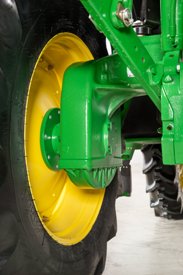 Rear drop axle
Rear drop axle
Benefit
- Additional crop clearance
Details
The drop axle features a flanged-type axle end that provides up to a maximum drop of 295 mm (11.6 in.) and can accommodate tread settings from 1524 - 2235 mm (60 to 88 in.). The hi-crop option is only compatible with 18.4R38-in. 141A8 R2 rear and 320/90R46-in. 148A8 R2 radial front wheels and tires or 320/90R50-in. 147A8 R1W rear and 320/90R50-in. 147A8 R1W radial front wheels and tires.
Loaders are not compatible with this configuration.
| Code | Description | Model |
| 5028 | High crop drop axle | 6155R |
CommandCenter™ display
Overview
The Generation 4 CommandCenter creates the primary user interface for 6R Series Tractors. The Generation 4 CommandCenter provides an excellent, user-savvy operating experience.
Producers can also use a variety of implements with the Generation 4 CommandCenter as it is ISOBUS virtual terminal (VT) capable.
Expect machine productivity gains, along with increased operator confidence, thanks to a simple, customizable interface. The reliability of the Generation 4 CommandCenter also aids in optimal operating experience and maximizes uptime.
 4200 CommandCenter 21.3-cm (8.4-in.) display
4200 CommandCenter 21.3-cm (8.4-in.) display
 4600 CommandCenter 25.4-cm (10-in.) display
4600 CommandCenter 25.4-cm (10-in.) display
Benefits
- Easy-to-change fields and guidance lines
- Custom-defined views
- On-screen help functions
- Intelligent warnings
- Context-based help
Details
| Code | Description |
| 1947 | 4200 Processor (21.3-cm [8.4-in.] display only) |
| 1946 | 4600 Processor (25.4-cm [10-in.] display only) |
| Code | Description |
| 1829 | 21.3-cm (8.4-in.) CommandCenter display (4200 Processor only) |
| 1822 | 25.4-cm (10-in.) CommandCenter display (4600 Processor only) |
| Code | Description |
| 1845 | Less activations |
| 1851 | CommandCenter AutoTrac™ activation 21.3-cm (8.4-in.) or 25.4-cm (10-in.) display |
NOTE: CommandCenter AutoTrac activation stays with the tractor.
NOTE: 6155RH only available with code 1845.
Layout manager
 Layout manager selection page
Layout manager selection page
 Layout manager module build
Layout manager module build
The Generation 4 CommandCenter features a modular-designed layout manager, so an operator can easily create the structure that meets the operator’s demands. From the factory, machines are equipped with standard run pages. An unlimited amount of run pages can be added to the Generation 4 CommandCenter based on operator preference or operational needs. Toggling between run pages is as easy as swiping the screen or using the arrow buttons on the top right portion of the title bar.
Users and access
Users and access allow the owner to lock out certain functions to prevent operators from accessing or changing settings. Lock-out functions are managed with an owner-defined four-digit code.
Lockout features are available for:
- Precision Ag Technology applications
- Hitch
- Hydraulic
- Transmission
- Power take-off (PTO)
- FieldCruise™ engine controls
- Display
- Machine monitor
On-screen help and diagnostic text
There are a number of different ways to get meaningful on-screen help when navigating the Generation 4 CommandCenter. Operators can find the help icon on the shortcut bar on the bottom of every page. This icon gives detailed information on everything from tractor operation to application information. Simply select the help icon and navigate to the information section that is needed.
 Help center main page
Help center main page
Additionally, application-based help is also available in all locations of the CommandCenter. Simply click on the (i) icon available on the title bar and it will lead directly to more information on the application currently being used.
 Context-based help iTEC™ main page
Context-based help iTEC™ main page
Diagnostic text and information is available for better understanding of whether applications are operating as directed.
Machine monitor
 Machine monitor page
Machine monitor page
The machine monitor application provides the user instantaneous readings about the status or condition of the machine. Values shown in the machine monitor vary by application, but typically include parameters like engine speed, coolant temperature, and ground speed. The machine monitor supports run page modules in the layout manager, allowing the user to populate specific machine parameters directly to a run page.
NOTE: The machine monitor application replaces part of the Universal Performance Monitor in previous machines.
 25.4-cm (10-in.) 4600 CommandCenter display
25.4-cm (10-in.) 4600 CommandCenter display
The 4200 Processor is base equipment on all 6R Tractors. It offers:
- Compatible with 21.3-cm (8.4-in.) touchscreen display
- One video camera input
- One USB input
- AutoTrac capable (machine-specific activation sold separately)
 John Deere 4200 CommandCenter
John Deere 4200 CommandCenter
A. Next run page
B. Status center
C. Expand shortcut keys
D. Menu
E. Run page
Work monitor
 Work monitor page
Work monitor page
The work monitor application displays the performance information about the task being performed by the machine. The user is shown averages, totals, and productivity of the machine, such as area worked, average working speed, and fuel usage. The values of the work monitor can be reset by the user at any time. Specific values of the work monitor can be configured by the user to be shown on a run page.
NOTE: The work monitor application replaces part of the universal performance monitor in previous machines.
Video capability
Tractors with a 4200 CommandCenter are equipped with one video input and tractors with a 4600 CommandCenter have two video inputs. The operator has the ability to set a variety of triggers, including reverse, PTO, hitch, and selective control valve (SCV) levers to activate the camera. The image will then appear on the CommandCenter display. The camera (video observation system) is available through JD Parts and Ag and Industrial (A & I) Products.
John Deere Generation 4 CommandCenter processors
A Generation 4 CommandCenter is made up of a processor and a display. Two processor options are available for the Generation 4 CommandCenter.
The 4600 Processor is the premium processor. Available features with the premium processor include:
- Compatible with 25.4-cm (10-in.) touchscreen display
- Two video camera inputs
- One USB input
- AutoTrac capable (machine-specific activation sold separately)
| Tractors | 4600 Processor | 4200 Processor |
| 6R | Option | Standard |
Display options
Generation 4 CommandCenter displays are available in the following configurations:
- 21.3-cm (8.4-in.) display on the 4200 CommandCenter
- 25.4-cm (10-in.) display on the 4600 CommandCenter
For those wanting to maximize their viewing real estate, the 26-cm (10-in.) touchscreen color display is an excellent choice. With the 26-cm (10-in.) display, the title bar and all shortcut keys may be viewed at all times. Operators can monitor more items at once on the 26-cm (10-in.) touchscreen display.
 John Deere 4600 CommandCenter
John Deere 4600 CommandCenter
A. Next and previous run page
B. Status center
C. Shortcut keys
D. Menu
E. Run page
F. Title bar
Rear-mounted selective control valves (SCVs)
Overview
To control a rear implement, up to six SCVs or five SCVs plus Power Beyond can be ordered (6145R-6250R). For (6110R- 6130R) up to five SCVs or four SCVs plus Power Beyond can be ordered. The SCVs can be controlled electrically. Up to four mechanical SCVs are available, in combination with Power Beyond. All mechanical or electrical SCVs feature four positions - neutral, raise, lower, and float.
Benefits
- Release levers make disconnecting hydraulic hoses easy
- Relocated valves improve operator's visibility to the rear hitch
- Up to six rear SCVs give operators total flexibility
| Code | Description | Information | Availability |
| 3312 | Two mechanical SCVs – premium | Premium couplers with high-pressure relief lever. Two mechanical SCVs 450 Series. Only in combination with PowrQuad™ Plus transmission or AutoQuad™ Plus transmission. Only available on 6110R - 6130R. |
6110R, 6120R, 6130R |
| 3332 | Three mechanical SCVs - premium | Premium couplers with high-pressure relief lever. Only in combination with PowrQuad Plus or AutoQuad Plus. | 6110R, 6120R, 6130R, 6145R, 6155R, 6175R, 6195R, 6215R |
| 3311 | Two electronic SCVs - premium | Premium couplers with high-pressure relief lever. | 6110R, 6120R, 6130R |
| 3331 | Three electronic SCVs - premium | Premium couplers with high-pressure relief lever. | 6110R, 6120R, 6130R, 6145R, 6155R, 6175R, 6195R, 6215R, 6230R, 6250R |
| 3341 | Four electronic SCVs - premium | Premium couplers with high-pressure relief lever. | 6110R, 6120R, 6130R, 6145R, 6155R, 6175R, 6195R, 6215R, 6230R, 6250R NOTE: Not available for 6155RH. |
| 3351 | Five electronic SCVs – premium | Premium couplers with high-pressure relief lever. When ordered with right-hand console, (code 2055) also electrical joystick (code 841L) for operation of rear SCVs or electrical midstack SCV (code 8922, 8923, 8914 or 8915) is required. A maximum of four SCVs can be operated via paddle pot at right-hand console. | 6110R, 6120R, 6130R, 6145R, 6155R, 6175R, 6195R, 6215R, 6230R, 6250R NOTE: Not available for 6155RH. |
| 3361 | Six electronic SCVs – premium | Premium couplers with high-pressure relief lever. Not with right-hand console (code 2055). Not in combination with electrical joystick (code 841L) and any option with electrical joystick. | 6145R, 6155R, 6175R, 6195R, 6215R, 6230R, 6250R NOTE: Not available for 6155RH. |
Mechanical control valves
Overview
The tractor may be equipped with one type of mechanical control valves: premium (450 Series).
Premium-couplers control valves also have an additional lock function (position 3), which holds the control lever in the raise or lower position until the pressure in the oil circuit has reached a predetermined value (e.g., when the control cylinder has reached its end position).
In position 2, the control lever returns to neutral as soon as it is released and is the setting for normal hydraulic operation.
If an implement is connected, pressure connection has to be connected to the lower coupler. With standard SCVs, a valve prevents sudden loss of pressure caused by leakage when the engine is shut off.
On premium SCVs, the likelihood of leakage is further diminished.
 Premium mechanical control valve (premium)
Premium mechanical control valve (premium)
- Position 1
- Position 2
- Position 3
- Hydraulic oil flow control
Electrical control valves
Overview
The tractor may be equipped with the premium (450 Series) control valves. All main characteristics can be controlled by the CommandCenter™ display.
 CommandCenter hydraulics option
CommandCenter hydraulics option
Example options of rear valve configuration
 3351 – five electronic SCVs (five SCV premium)
3351 – five electronic SCVs (five SCV premium)
 3361 – six electronic SCVs (six SCV premium)
3361 – six electronic SCVs (six SCV premium)
Hydraulic control options
 E-SCV controls on the right-hand console
E-SCV controls on the right-hand console
 M-SCV controls on the right-hand console
M-SCV controls on the right-hand console
 E- SCV controls on CommandARM™ controls
E- SCV controls on CommandARM™ controls
 E-SCV controls on optional joystick (reconfigurable)
E-SCV controls on optional joystick (reconfigurable)
Hydraulic set up
Shortcut button right-hand console
Overview
Simply push the hydraulic symbol on the right-hand side console or the CommandCenter and the CommandCenter display shows a setup menu to:
- Monitor valve status - detent, float, or neutral
- Adjust maximum flow and detent (combine for both direction or separate extent and retract adjustment)
 Hydraulic shortcut button on right-hand console
Hydraulic shortcut button on right-hand console
 Hydraulic shortcut button CommandCenter
Hydraulic shortcut button CommandCenter
Detent setup
Overview
- Time detent - this is particularly useful when repeat SCV operations are performed, such as lowering a mower-conditioner plow or cycling planter markers.
- Continuous flow detent - this is particularly useful when a hydraulic motor is used, such as on an air seeder.
 Detent setup
Detent setup
SCV flow setup
Overview
SCV flow rate can be programmed between 0.04 and 10 allowing fine tuning for implements with different hydraulic requirement.
Behavior can be set between linear (red), progressive (green), or a combination (yellow) for exact flow modulation and precise valve management.
- Linear means that the distance travelled by the SCV/ICV corresponds to the distance travelled by the control lever/multifunction lever
- Progressive means that initially the distance travelled by the SCV/ICV is less than that travelled by the control lever/multifunction lever (giving a more sensitive start to the movement)
 Flow setup
Flow setup
 Three flow options
Three flow options
 Flow characteristic setup
Flow characteristic setup
Combination is an intermediate stage between the two settings listed above.
ComfortView™ operator environment
Overview
ComfortView cabs feature a modern, automotive-style instrument panel as base equipment. The instrument pod has two large analog dials for engine and tractor speed, as well as two smaller dials that display fuel level, DEF level, and coolant temperature. The steering column and dash are adjustable to suit the operator's needs. The column tilts toward the operator and a lever on the left-hand side allows for the column to telescope out to the desired level.
A dimming mode automatically reduces the brightness of the instrument illumination when the tractor lights are used.
Steering column control panel
 Cab and controls 6R Tractor
Cab and controls 6R Tractor

Instrumentation control panel
Overview
The instrumentation panel has a row of information and warning lights across the bottom to monitor all important tractor functions. A three-stage warning system first gives information, then gives warnings, and finally, gives a stop alarm to prevent damage from occurring in the event of a component malfunction. An integrated power take-off (PTO) over-speed warning is incorporated into the diagnostics to ensure proper operation.
 Instrumentation control panel
Instrumentation control panel

Dash instrument panel controls include:
| Left side | Right side |
| Left-hand reverser | Two-speed and optional intermittent wiper |
| High-/low-beam switch | Key start/stop |
| Hazard switch | Road/work lights on/off |
| Turn signals/horn |
In-cab storage
 Overhead storage compartment
Overhead storage compartment
Right-hand console controls
Overview
The right-hand control console is angled for operator comfort and ease of operation. The design of the right-hand console is controlled by the type of SCVs chosen.
Mechanically actuated valves are controlled by traditional levers, while electronically actuated valves are controlled by fingertip paddle pods. Controls for the ComfortView cab are grouped by function on the right-hand console.
The modular console panel provides individual access to hand throttle, transmission controls, MFWD switch (if equipped), hitch command console, load/draft control, SCV, and PTO controls.
The console is also the location of the CommandCenter. The CommandCenter allows the operator to customize important tractor functions.
This option requires a PowrQuad™ or AutoQuad™ transmission.
 ComfortView cab right-hand console (AutoQuad transmission is shown)
ComfortView cab right-hand console (AutoQuad transmission is shown)
 Hitch control module on right-hand console
Hitch control module on right-hand console
 M-SCV controls on the right-hand console
M-SCV controls on the right-hand console
 E-SCV controls on the right-hand console
E-SCV controls on the right-hand console
Benefits
- Ergonomic placement of controls to match arm movements
- Integrated hitch control module with draft wheel
Cab packages for 6155RH
| Cab packages | Economy right-hand console |
Standard right-hand console |
Premium right-hand console | Premium right-hand console cab suspension |
| Package code | 2051 |
2061 |
2065 |
2069 |
| One panorama door (left hand only) | X |
X |
||
| Two panorama doors (left-hand and right-hand sides) | X |
X |
||
Air seat (Sears) |
X |
X |
X |
|
| Deluxe air seat (Grammer® DDS) | X |
|||
| Instructional seat | X |
X |
X |
|
| Bottle holder | X |
X |
X |
|
| Mirrors - right hand and left hand - manually adjustable and telescopic | X |
X |
||
| Wide-angle mirrors - right hand and left hand - electrically adjustable | X |
X |
||
| Front sun visor | X |
X |
||
| Front and rear roller blind | X |
X |
||
| Rear wiper and washer | X |
X |
X |
|
| Manual temperature controls | X |
X |
||
| Automatic temperature controls | X |
X |
||
| Hydraulic cab suspension | X |
*NOTE: 6155RH right-hand console only
Grammer is a trademark of Grammer Aktiengesellschaft Joint Stock Company.
PowerTech™ PVS/PSS Stage 4 engine
Overview
John Deere 6R Series Tractors feature the reliable and proven PowerTech PVS 6.8L and PSS 4.5L and 6.8L engines. These air-to-air aspirated engines deliver a power bulge above rated power to provide excellent torque in demanding applications.
Key features:
- Series turbochargers (PSS only)
- Variable geometry turbocharger (VGT)
- Air-to-air after cooling
- High-pressure common rail (HPCR) fuel system
- Engine control unit (ECU)
PowerTech PSS/PVS engine identification
 |
After treatment
|
Turbocharger
|
|
Technology
|
 PowerTech PSS 6.8L engine
PowerTech PSS 6.8L engine

Benefits
- A constant power range of 2100 rpm down to 1500 rpm
- Power bulge of 10 percent
- Greater tractor productivity
- Responsive power reducing the need to downshift the transmission
Details
To match the engine power characteristics and improve the operation economy of the machine, the rated engine speed is 2100 rpm.
Series turbochargers
Overview
The PowerTech PSS 4.5L and 6.8L utilizes two turbochargers – a VGT and a fixed geometry turbocharger, providing the torque rise and engine response needed to meet varying load conditions.
Fresh air is first drawn into the low-pressure fixed geometry turbocharger and compressed to a higher pressure. The compressed, higher pressure air is then drawn into the high-pressure VGT, where the air is further compressed. By splitting the work between two turbochargers, both can operate at peak efficiency and at slower rotating speeds.
 PowerTech PSS engine series turbochargers
PowerTech PSS engine series turbochargers

Benefits
- Deliver high power density
- More low-speed torque and responsiveness to meet varying load conditions
VGT
Overview
The VGT is electronically controlled and actuates the turbo vanes as required to maintain peak engine performance.
The turbocharger’s vanes are in the exhaust flow. The opening or closing of the vanes changes the outlet volume and airflow speed against the turbocharger turbine. When exhaust flow is low, the vanes are partially closed. This partial closure increases the pressure against the turbine blades to make the turbocharger spin faster and generate more boost pressure.
The ability to keep the airflow at optimum levels provides more consistent engine boost pressure and the ability to respond to load quickly across the entire engine rpm range. This system is without the turbo lag that can be found on some engines.
 PowerTech VGT
PowerTech VGT

Benefits
- Increased low rpm torque
- Quicker response to load
- Increased peak torque
- Improved fluid economy
- Improved performance at high altitudes
Air-to-air after cooling
Overview
Air-to-air after cooling lowers the intake manifold air temperature and provides more efficient cooling while reducing cylinder firing pressure and temperatures for greater engine reliability. Since lower temperature air is denser, a higher volume of air flows into cylinders so the engine is capable of meeting the increasing horsepower demands. Lowering the intake manifold and cylinder temperatures also aid in lowering the combustion temperature, which lowers the NOx produced as a result.
Benefits
- Higher horsepower
- Less NOx production
HPCR fuel injection system
Overview
Every PowerTech PSS 4.5L and 6.8L engine utilizes a HPCR fuel system to efficiently supply fuel to injectors. The high-pressure fuel pump instantly responds to requirements for more or less fuel flow or pressure. This electronically controlled, high-pressure pump delivers pressure on demand according to the application requirements. Pressure on demand ensures an efficient injection system resulting in high-injection pressure independent of engine speed.
 High-pressure common rail
High-pressure common rail

Benefits
- Instantly respond to load changes reducing the need to change gears
- Improved fluid economy
Engine control unit (ECU)
Overview
The ECU uses signal inputs from sensors and pre-programmed performance modeling to control critical engine functions such as fuel quantity, injection timing, air-to-fuel ratio, multiple fuel injections, amount of cooled exhaust gas recirculation (EGR), and a host of other control parameters.
 ECU
ECU

Benefits
- Optimized fluid economy
- Maximum engine performance
Details
Each injector is controlled individually by the ECU. The ECU turns the injector on and off during each firing cycle to control the fuel delivery into each cylinder.
Load and speed sensing allows each cylinder’s fuel delivery rate to be adjusted independently at the individual injector. With each injection cycle, the ECU can make the following adjustments on the go:
- Number of injections
- Fuel pressure in the common rail
- Start of injection
- Duration of injection
This management system is connected to the transmission, allowing the engine and transmission to respond simultaneously.
Cold weather and high-altitude compensation are also precisely controlled for quality starts regardless of weather and maximum performance at high elevations. The ECU also features improved diagnostic capabilities. It is faster, has more working memory, and is responsible for monitoring and executing all aspects of the Integrated Emission Control System.
Lighting options provide maximum visibility in every direction
Overview
Lights on the 6R Series Tractors have been positioned and designed to provide maximum visibility to the front, sides, and rear of the tractor to increase productivity in any operating condition. The cab lighting pattern provides 330 degrees of coverage while the hood lighting provides the remaining 30 degrees, for completely programmable, 360-degree, stadium-style lighting.
Base lighting
- Two HB3 hood road lights - low beam (A)
- Two HB3 hood road lights - high beam (B)
- Two HB3 hood outer work lights (C)
- Two H4 belt-line lights (F)
- Four HB3 halogen inner front-roof-mounted adjustable work lights (H and I)
- Two HB3 halogen inner rear-roof-mounted adjustable work lights (N)
- Brake lights rear fender mounted (R)
Code |
Hood |
Belt |
Front roof |
Side |
Rear roof |
Fender |
|||||||||
A |
B |
C |
E |
F |
G |
H |
K |
I |
L |
N |
O |
P |
R |
||
| * Base package - with non-panorama roof | HB3 | HB3 | HB3 | NA | H4 | X | HB3 | HB3 | HB3 | X | HB3 | ||||
| Light package - Standard | 873F | HB3 | HB3 | HB3 | NA | H4 | X | HB3 | X | HB3 | HB3 | HB3 | X | HB3 | HB3 |
| Light package - Premium | 873E | HB3 | LED | LED | NA | LED | X | LED | X | LED | LED | LED | X | LED | HB3 |
| Light packages panorama roof code (878W) | |||||||||||||||
| Light package - Standard - panorama roof | 873A | HB3 | HB3 | HB3 | NA | H4 | X | LED | X | HB3 | HB3 | X | HB3 | HB3 | |
| Lighting package – Panorama light package | 873C | HB3 | LED | LED | NA | LED | X | LED | X | LED | LED | X | LED | HB3 | |
Light-emitting diode (LED)
High-intensity discharge/Xenon (HID)
Halogen (HB3)
 Lighting identification from front view of tractor
Lighting identification from front view of tractor
 Lighting availability on panorama roof
Lighting availability on panorama roof
 Lighting identification from rear view of tractor
Lighting identification from rear view of tractor
NOTE: Please also see available attachments.
Selecting the lighting mode
Overview
Operators can quickly select a lighting mode on the steering console by operating a rotary switch. The three settings available are:
- Light switch in the off position
- Headlights in road mode
- Headlights and work lights in field mode (depending on CommandCenter™ display assignments)
 Lighting control switch on dashboard
Lighting control switch on dashboard
Benefits
- Easy to locate and operate
- Small and compact design
Programmable lighting
Overview
The CommandCenter allows operators to customize two different light programs. The operator can switch between the two programs with the push button. Also standard on the 6R Tractors is the battery power-saver feature. When the engine is off and the outside lights have been left on, this feature is designed to avoid battery run-down. After the lights have been left on for 30 minutes and the key is in the off position, the lights will cycle, or blink on and off, five times as an alert. The lights will continue to illuminate for one more minute and then automatically shut off to protect the battery.
 CommandCenter programmable timeout lighting
CommandCenter programmable timeout lighting
 CommandCenter programmable lights page
CommandCenter programmable lights page
 Beacon lights/hazard warning lights, work light 1 and 2 location on right-hand console
Beacon lights/hazard warning lights, work light 1 and 2 location on right-hand console
 Beacon lights/hazard warning lights, work light 1 and 2 location on CommandCenter
Beacon lights/hazard warning lights, work light 1 and 2 location on CommandCenter
Benefits
- The John Deere light programming adds high performance to the operator.
- Individual light selection adds to high operator performance to prevent blinding other operators when two machines are working close to each other.
- Improved uptime due to 360-degree lighting.
More lighting information
Overview
Optional LED lighting technology provides better depth perception and pattern recognition as well as a natural low temperature light for excellent definition of the field. One LED light will out-live 200 or more incandescent lights, 55 or more halogen lights, and 14 or more HID lights.
Beltline and rear fender work lights
Overview
Beltline and rear fender work lights provide options for full light flexibility, giving flood illumination exactly where the operator needs it. The John Deere beltline lights are available with HB3 work lights and LED work lights. The two rear fender lights are available in HB3 or LED.
The John Deere lighting components have undergone numerous vibration testing procedures to ensure a good lighting performance and sturdiness under all conditions.
All work lights and beltline lights are adjustable to a desirable angle.
Two beltline work lights - LED
 Two beltline work lights – LED
Two beltline work lights – LED
Benefits
- Less eyestrain on approaching traffic when traveling on the road.
- Saves the operator on service time and money and minimizes downtime.
- The LED bulbs and diodes have an outstanding operational lifetime to last the tractor's full running lifetime, thus giving the operator greater uptime.
Details
- Mounted at beltline at front of cab.
- No hanging work lights are possible. Not in combination with second beltline lights (873M and 873O).
| Code | Description |
| 873C | Part of Premium panorama roof light package |
873E |
Part of Premium light package |
NOTE: Please also see available attachments.
Two rear fender work lights – HB3
 Two rear fender work lights – HB3
Two rear fender work lights – HB3
Benefits
- The two rear HB3 work lights, ensure good performance for the cost-sensitive producer.
NOTE: These lights should not be operated during road transport.
| Code | Description |
| 873A | Part of Standard panorama roof light package |
| 873F | Part of Standard light package |
NOTE: Please also see available attachments.
Beacon light for added visibility
Overview
A beacon light is mounted on the front of the cab to provide a rotating warning light for road traveling and added visibility.
Two beltline lights - H4
 873M - Two beltline lights – H4
873M - Two beltline lights – H4
Benefits
- The two beltline lights provide greater illumination toward the front wheels of the tractor.
Details
- Mounted at beltline at front of cab
- No hanging work lights are possible. Not in combination with second beltline lights (code 873M and 873O).
| Code | Description |
| 873A | Part of Standard panorama roof light package |
| 873F | Part of Standard light package |
NOTE: Please also see available attachments.
Two rear fender work lights – LED
 Two rear fender work lights – LED
Two rear fender work lights – LED
Benefits
- The John Deere lighting components have undergone numerous vibration testing procedures to ensure a good lighting performance and sturdiness under all conditions.
- The LED rear fender light adds extra lighting when operating implements close to the ground.
NOTE: These lights should not be operated during road transport.
| Code | Description |
| 873C | Part of Premium panorama roof light package |
| 873E | Part of Premium light package |
NOTE: Please also see available attachments.
Benefits
- To warn other road users of the presence of a large machine on the road.
- Easily removed with no tools required when approaching height restricted areas.
- Waterproof to ensure good performance when required.
- The beacon has a degree of flexible movement, are not completely static, and can withstand the impact of objects such as tree branches.
Details
- Front cab is roof mounted.
| Code | Description |
| 873A | Part of Standard panorama roof light package |
| 873C | Part of Premium panorama roof light package |
| 873F | Part of Standard light package |
| 873E | Part of Premium light package |
Features
Premium cab for the ultimate operating experience
The premium cab is designed to provide the ultimate in comfort and convenience. This cab includes all of the features of the standard cab operator station plus much more. Some of the key features include:
- Deluxe sound package with two 4X6 coaxial speakers and subwoofer
- Factory-installed radio
- Bluetooth® ready
- Satellite ready
- USB port
- Auxiliary cord connection
- Additional heating and cooling vents
- Rear windshield wiper and washer
- Loader view window with sun shade
- Rear floor mat
 Key features of the premium cab
Key features of the premium cab
The rear floor mat behind the seat provides additional storage space. To shield the operator from the sun, there is an easy to use front sun shade with a scissor-style design. There is an overhead console with speakers and a map light. The Bluetooth microphone is strategically located for ample sound detection. The rearview mirror is positioned for excellent visibility to rear operations. The premium cab comes with a Bosch® deluxe radio, and offers both an auxiliary and a USB port to charge and connect custom electronic devices. The satellite radio-ready feature makes it easy for customers to convert the sound system to any available service. The sound system includes two 4x6 co-ax speakers in the front of the cab and a subwoofer with amp and crossover.
The loader view window or sun roof has a single handle to open and close and once latched, the sun shade moves with the window.
The auxiliary plug-in as well as the USB connection provide a way to play music through an iPod® or MP3 player.
 Deluxe sound package and loader window
Deluxe sound package and loader window
 Factory-installed radio
Factory-installed radio
 Rigid front sun shade
Rigid front sun shade
 Loader window sun shade and vent
Loader window sun shade and vent
 Bluetooth microphone
Bluetooth microphone
 Auxiliary cord connection
Auxiliary cord connection
 Rear floor mat
Rear floor mat
Bluetooth is a trademark of Bluetooth SIG Incorporated. iPod is a trademark of Apple Inc. Bosch is a trademark of Robert Bosch GmbH.
Power bulge and torque reserve pull through the tough spots
5M Final Tier 4 (FT4) engines feature up to a 4 percent power bulge when put under load. The power bulge feature of the electronically controlled engine delivers additional horsepower as engine rpm drops below rated speed. Additionally, a 30 percent torque rise provides the force that maintains horsepower as engine rpm drops below rated speed.
When the tractor is under load, power bulge and torque rise work together to get through the tough spots without having to downshift. Horsepower and torque are mathematically related.
 |
As rpm drops, the only way to maintain or increase horsepower is to provide additional torque. The output horsepower is greater than or equal to rated horsepower as the engine is pulled down to 1750 rpm.
The peak torque rise also occurs near the rated economy power take-off (EPTO) speed.
 5M power curve summary
5M power curve summary
 5M torque curve summary
5M torque curve summary
Heavy-duty 3-point hitch lift capacity for implement versatility
A Category 2, 3-point hitch on 5M Tractors provides the lift capacity and compatibility to perform in a variety of different applications. With the choice of either mechanical or electrohydraulic hitch controls, hooking up implements is convenient with telescoping draft links, adjustable sway bars, and interchangeable hitch balls. Both mechanical and electrohydraulic hitch controls have a depth stop. This feature provides consistency when lowering the hitch. Each time the position control lever is pushed forward, it stops where the depth stop has been positioned. This is valuable to anyone who desires a consistent, level ground, like when preparing a seedbed.
The 3-point hitch adapts to a wide variety of implements and has plenty of lift capacity to handle heavy implements such as planters, sprayers, and field cultivators. The 65-mm (2.5-in.) external cylinders provide for a hitch lift capacity of 2340 kg (5159 lb) at 610-mm (24 in.) behind the hitch-lift balls throughout the lifting range.
 5M 3-point hitch
5M 3-point hitch
5115M Tractors come equipped with one 65-mm (2.5-in.) and one 75 mm (2.9-in), averaging to 70 mm (2.7-in) lift cylinders which provide for 2701 kg (5954 lb) of lift capacity at 610-mm (24-in.) behind the hitch-lift balls, throughout the lifting range. Any 5M Series Tractor has the option of selecting these larger lift cylinders through the factory or a field-installed heavy-duty hitch kit.
Adjustable sway bars and telescoping draft links can be easily adjusted to adapt to a wide variety of implements. The right lift link also adjusts without tools for added convenience when leveling implements. Operators do not need to carry a tool to adjust the rear hitch. Operators can also raise and lower the 3-point hitch from outside of the tractor with the conveniently located rear fender hitch controls.
 5M sway bars
5M sway bars
 5M rear fender hitch controls
5M rear fender hitch controls
Mid-frame design for support and strength
The exclusive mid-frame design on the 5M Series offers additional strength and durability but also reduces noise and vibration. Because the mid frames are made from hardened cast steel they provide the tractor strength and stability even in the toughest conditions.
The mid frames also support and protect different pieces of essential equipment. The hydraulic pump, located between the mid-frames, is attached to the transmission for short hydraulic lines and simplified fluid flows. An optional mid-mount fuel tank allows the tractor to carry an extra 9 gal. (34L) on cab tractors and an extra 7.8 gal. (29.5L) on OOS tractors. This is especially useful for long days in the field or when a trip to fill up with diesel may not be convenient.
The mid frames are compatible with current loader mounting frames, which is beneficial for those interested in upgrading their tractors and keeping their H-Series Loaders.
Features
Low-profile standard open operator station (OOS)
The standard OOS on 5ML Tractors was designed for low-clearance applications. It features a low-profile seat, a smaller-diameter steering wheel, protected controls, and a low-profile, rear-mounted rollover protective structure (ROPS). Combined with the sloping hood, this is beneficial to the operator’s visibility to the front of the tractor. Rounding off these standard features and incorporated into each operator platform is a shield which limits heat transfer from the hydraulics to the operator.
All of the most crucial operator controls are conveniently located within arms’ reach on the right-hand console control pod. The engine throttle control, selective control valve (SCV) levers, power take-off (PTO) engagement, and hitch-lift control levers are grouped together. On the 5ML, this control pod is positioned on the right-side fender, protected from low-hanging crops by a shield.
 Right-hand fender shield and low profile seat
Right-hand fender shield and low profile seat
Color-coded bands on the SCV levers correspond with the color on the rear SCVs, making it easy for any operator to determine which lever operates which rear SCV.
The 5ML Tractor also offers optional fender extensions to minimize crop disturbance, especially in orchards or tree nut applications. Two fender extension options are available to meet varying tire sizes and coverage preferences.
The foldable ROPS on the 5ML Tractor has a unique design and is 15.2-cm (6-in.) lower at maximum height than the standard 5M Tractors.
The shifter linkages are tighter to offer a more accurate shift pattern, which translates to a crisper throw between gears. Incorporating technology found on standard 5M Tractors, the 5ML now offers a declutch button, enabling the operator to shift gears within a range without the use of the foot clutch.
Dash details:
- Cluster
- Controls
- Steering wheel
5ML Tractors also include the following features:
- Retractable seat belts
- Rear certified ROPS for OOS tractors
- Heat shield limiting hydraulic heat passed onto the operator
- Key-switch interlock prevents bypass starting
- Audible and visual PTO warning alerts when the operator leaves the seat with the PTO engaged
- Positive park position prevents the tractor from moving when the engine is off
- Four amber turn-signal/flashing warning lights for road transport (these are break-away)
- Slow-moving vehicle (SMV) sign alerts other road users during transport
- Safety decals keep safety in the minds of new and experienced operators
- Left- and right-hand steps provide easy and convenient access from both sides of the tractor
- Fuel system is fully grounded to meet safety and fuel fill regulation requirements
- For convenience of operation, the fuel and diesel exhaust fluid (DEF) fill are both on the same side with clearly marked and color coded caps. The DEF tank has a capacity of 12.1-L (3.2 gal.), which is more than enough to sustain proper tractor operation and fuel treatment for more than one full tank of diesel. A field-installed lockable fuel cap is offered for protection and peace of mind.
Transmission controls on PowrReverser™ transmission models:
Gear and range shift levers are located to the right of the operator. The gear lever incorporates a declutch button enabling the operator to shift gears without the use of the foot clutch. Unique knobs also make it easier to distinguish between the two.
 Gear lever with declutch button
Gear lever with declutch button
Transmission controls on PowrQuad™ transmission models:
A single transmission control is located to the right of the operator. This control features the ability to shift through gears within a range using the rabbit button to increase gears and the turtle button to decrease gears. A range change can be completed with this control, as well by moving through A-D ranges similar to a traditional range controller. To aide in ease of operation, operators can use the integrated declutch button rather than the foot clutch to change ranges.
 Transmission control on PowrQuad transmission models
Transmission control on PowrQuad transmission models
A foot throttle with a platform pedal is located on the right side of the operator. The pedal is positioned for ease of use, yet does not clutter the floor. The hand throttle is easily accessible on the right hand console.
Engaged by either foot, the differential lock pedal is placed on the floor.
 Differential lock button
Differential lock button
When the tractor is used in applications requiring the clutch and brake pedals to be used frequently, the operator will see the benefit of the suspended pedals.
The electrohydraulic forward/reverse direction lever is located on the left-hand side of the instrument console, connected to the steering column. There is also a guard for the reverser lever. Operated with the left-hand finger, the right hand is free to simultaneously run the loader, hitch, or hand throttle.
 Left hand reverser with guard
Left hand reverser with guard
3-point hitch controls
Mechanical hitch controls are available on models equipped with a PowrReverser transmission, while models equipped with a PowrQuad transmission will have an electrohydraulic (EH) hitch. With an EH hitch, operators will have the functionality to raise and lower the hitch from the rear left-hand fender, reducing time when attaching and detaching implements.
 Left-hand fender hitch control
Left-hand fender hitch control
PTO controls and speeds
The 5ML features electrohydraulic PTO engagement on all models.
The push/pull knob on open station tractors is conveniently located beside the hand throttle on the right-hand side of the operator. When the PTO is engaged, a light on the instrument panel will illuminate and PTO speed is indicated by target bars. Models equipped with a PowrReverser transmission have a 540/540E rpm shiftable PTO while models equipped with a PowrQuad transmission have a three-speed PTO, 540/540E/1000 rpm.
Enhancing operator safety, the tractor does not start with the PTO engaged. An alarm sounds if the operator attempts to leave the seat with the PTO engaged. The PTO shaft is protected by a hinged shield.
Hydraulics controls
The color-coded bands on the levers, which control triple rear SCVs, correspond to the color of the dust cap and the SCV valve they control.
Mechanical front-wheel drive (MFWD) controls
All four-wheel drive (4WD) axles are equipped with the engage-on-the-go MFWD. This toggle switch is now located on the right-hand console.
Lighting controls – Multi-position dial
The five-position lighting package is straightforward with the lighting control switch on the right side of the steering column. The switch positions are: off, warning, work light, transport 1 (warning and high-beam headlights), and transport 2 (warning and headlights). A turn-signal lever is located on the left side of the steering column for quick and easy use.
Power bulge and torque reserve pull through the tough spots
5M Final Tier 4 (FT4) engines feature up to a 4 percent power bulge when put under load. The power bulge feature of the electronically controlled engine delivers additional horsepower as engine rpm drops below rated speed. Additionally, a 30 percent torque rise provides the force that maintains horsepower as engine rpm drops below rated speed.
When the tractor is under load, power bulge and torque rise work together to get through the tough spots without having to downshift. Horsepower and torque are mathematically related.
 |
As rpm drops, the only way to maintain or increase horsepower is to provide additional torque. The output horsepower is greater than or equal to rated horsepower as the engine is pulled down to 1750 rpm.
The peak torque rise also occurs near the rated economy power take-off (EPTO) speed.
 5ML power curve summary
5ML power curve summary
 5ML torque curve summary
5ML torque curve summary
16F/16R PowrReverser™ transmission (5100ML and 5115ML)
The PowrReverser transmission provides 16F/16R speeds. This transmission comes standard with a dual-speed 540/540 Economy power take-off (PTO) and is ideal for applications requiring frequent directional changes.
Hydraulic wet forward and reverse clutches maximize durability and outlast the life of any dry clutch. When tractors are run by multiple operators with a variety of experience levels, a wet clutch is the best way to maintain transmission integrity and performance while decreasing clutch replacement costs.
Two platform-mounted levers offer easy and comfortable shifting for a pleasant operator experience. The gear-shift lever is easy to reach and the less-used range lever is shorter. Unique knobs make it easy to distinguish between the two. Also incorporated into the gear shift lever is the declutch button. No foot clutching is required to shift between gears within a range.
NOTE: The PowrReverser transmission is not available for the 5125ML tractor.
 Integrated declutch button on gear shifter
Integrated declutch button on gear shifter
The forward lever, or gear shifter, selects one of four speeds, all which are synchronized shifts for on-the-go shifting with the use of the clutch or declutch button. The rear lever selects ranges A, B, C, or D. Ranges C and D are fully synchronized. That means, when upshifting, operators can move from range C to D without stopping the tractor. On the downshift, operators can move from D all the way to B without stopping.
Maximum productivity is achieved with clutchless hydraulic shifting between forward and reverse and is ideal for loader work and any other applications that require frequent directional changes in tight spaces. An electrohydraulic fingertip directional lever control allows the operator to effortlessly switch directions with a small finger motion.
This control is located on the left side of the instrument console and selects forward, reverse, and neutral positions. It also allows the operator to steer and shift direction with the left hand, freeing the right hand to operate other tractor controls, such as the loader, rear implements, or hand throttle. The PowrReverser transmission has a built-in engagement override valve for additional safety. This valve requires the clutch pedal to be depressed one time after each engine start before the transmission will begin to operate normally, giving the operator another opportunity to put all focus on the tractor.
NOTE: A neutral start switch requires the directional lever be in the neutral position to start the engine.
The speed of directional changes can be adjusted to the operator's preference or application demands with the field-installed infinitely variable control kit.
The 16F/16R transmission includes:
- Wet clutch
- Platform-mounted shift levers (four gears, four ranges)
- Declutch button on the gear lever
- Left-hand reverser
- Constant-mesh, helical-cut gears
- Pressure-lubricated top shaft
- Positive park pawl
- Neutral start switch
All tractors have economy PTO (E-PTO), a fuel saving feature that allows producers to operate rear implements at 540 PTO rpm but at lower engine rpm. The result is lower engine vibration, reduced noise, less wear and tear on the engine, reduced fuel consumption, and increased operator comfort.
NOTE: See PTO functional area for more information on E-PTO.
PowrQuad™ transmissions
The PowrQuad™ transmission can be ordered on any of the 5ML Tractor models with three different options to meet producer needs: 16F/16R PowrQuad, 16F/16R PowrQuad with creeper, or 32F/16R Power 8. These three transmissions options come standard with a 540/540 Economy/1000 power take-off (PTO) and are compatible with the pressure-and-flow compensated (PFC) hydraulic system.
Pairing a PowrQuad or a Power 8 transmission with PFC hydraulics provides more hydraulic flow, increased hitch lift capacity over PowrReverser models, and an electrohydraulic (EH) hitch control for repeatable hitch movements.
The ergonomically placed transmission control allows the operator to change gears and ranging with one simple control. Two buttons, a rabbit or turtle indicator, allow one to gear up (rabbit) or gear down (turtle) within a range. A range change can be made with a simple press of the declutch button rather than using the foot clutch. If preferred, the foot clutch remains incorporated into the operator station for use.
 Integrated declutch and gear buttons on transmission control
Integrated declutch and gear buttons on transmission control
Ranges on the transmission control can be selected by moving the controller in an H pattern. The lever selects ranges A, B, C, or D. Ranges C and D are fully synchronized. That means, when upshifting, operators can move from range C to D without stopping the tractor. On the downshift, operators can move from D all the way to B without stopping.
Maximum productivity is achieved with clutchless hydraulic shifting between forward and reverse and is ideal for loader work and any other applications that require frequent directional changes in tight spaces. An electrohydraulic fingertip directional lever control allows the operator to effortlessly switch directions with a small finger motion.
This control is located on the left side of the instrument console and selects forward, reverse, and neutral positions. It also allows the operator to steer and shift direction with the left hand, freeing the right hand to operate other tractor controls, such as the loader, rear implements, or hand throttle.
NOTE: A neutral start switch requires the directional lever be in the neutral position to start the engine.
PowrQuad transmissions include:
- Wet clutch
- Ergonomically mounted transmission lever controlling both gear and range changes
- Declutch button on the range lever
- Left-hand reverser
- Constant-mesh, helical-cut gears
- Pressure-lubricated top shaft
- Positive park pawl
- Three-speed PTO
- Neutral start switch
Reversible stub shaft
All 5ML Tractors equipped with a PowrQuad or Power 8 transmission have a reversible stub shaft with six splines and 21 splines (38 mm [1.5 in.]). To switch between 540 and 1000 speeds, simply remove the snap ring, flip the PTO shaft, and reinstall the snap ring. The tractor PTO operates at 540-rpm speed when the six-spline end of the shaft is visible, and at 1000 speed when the 21-spline end of the shaft is visible.
The reversible 540/ 540E/1000 PTO stub shaft is located in a dry cavity to allow changing from 540/540E rpm to 1000 rpm or vice versa without any oil spillage. This interchangeability allows the matching of different implements. The reversible stub shaft improves uptime as no bolts are needed for removal, just a simple snap ring.
 |
 |
A = snap ring B = snap ring groove C = bore |
| Reversible stub shaft (six and 21 splines) | ||
NOTE: See PTO functional area for more information on economy PTO.
Features
Low-profile standard open operator station (OOS)
The standard OOS on 5ML Tractors was designed for low-clearance applications. It features a low-profile seat, a smaller-diameter steering wheel, protected controls, and a low-profile, rear-mounted rollover protective structure (ROPS). Combined with the sloping hood, this is beneficial to the operator’s visibility to the front of the tractor. Rounding off these standard features and incorporated into each operator platform is a shield which limits heat transfer from the hydraulics to the operator.
All of the most crucial operator controls are conveniently located within arms’ reach on the right-hand console control pod. The engine throttle control, selective control valve (SCV) levers, power take-off (PTO) engagement, and hitch-lift control levers are grouped together. On the 5ML, this control pod is positioned on the right-side fender, protected from low-hanging crops by a shield.
 Right-hand fender shield and low profile seat
Right-hand fender shield and low profile seat
Color-coded bands on the SCV levers correspond with the color on the rear SCVs, making it easy for any operator to determine which lever operates which rear SCV.
The 5ML Tractor also offers optional fender extensions to minimize crop disturbance, especially in orchards or tree nut applications. Two fender extension options are available to meet varying tire sizes and coverage preferences.
The foldable ROPS on the 5ML Tractor has a unique design and is 15.2-cm (6-in.) lower at maximum height than the standard 5M Tractors.
The shifter linkages are tighter to offer a more accurate shift pattern, which translates to a crisper throw between gears. Incorporating technology found on standard 5M Tractors, the 5ML now offers a declutch button, enabling the operator to shift gears within a range without the use of the foot clutch.
Dash details:
- Cluster
- Controls
- Steering wheel
5ML Tractors also include the following features:
- Retractable seat belts
- Rear certified ROPS for OOS tractors
- Heat shield limiting hydraulic heat passed onto the operator
- Key-switch interlock prevents bypass starting
- Audible and visual PTO warning alerts when the operator leaves the seat with the PTO engaged
- Positive park position prevents the tractor from moving when the engine is off
- Four amber turn-signal/flashing warning lights for road transport (these are break-away)
- Slow-moving vehicle (SMV) sign alerts other road users during transport
- Safety decals keep safety in the minds of new and experienced operators
- Left- and right-hand steps provide easy and convenient access from both sides of the tractor
- Fuel system is fully grounded to meet safety and fuel fill regulation requirements
- For convenience of operation, the fuel and diesel exhaust fluid (DEF) fill are both on the same side with clearly marked and color coded caps. The DEF tank has a capacity of 12.1-L (3.2 gal.), which is more than enough to sustain proper tractor operation and fuel treatment for more than one full tank of diesel. A field-installed lockable fuel cap is offered for protection and peace of mind.
Transmission controls on PowrReverser™ transmission models:
Gear and range shift levers are located to the right of the operator. The gear lever incorporates a declutch button enabling the operator to shift gears without the use of the foot clutch. Unique knobs also make it easier to distinguish between the two.
 Gear lever with declutch button
Gear lever with declutch button
Transmission controls on PowrQuad™ transmission models:
A single transmission control is located to the right of the operator. This control features the ability to shift through gears within a range using the rabbit button to increase gears and the turtle button to decrease gears. A range change can be completed with this control, as well by moving through A-D ranges similar to a traditional range controller. To aide in ease of operation, operators can use the integrated declutch button rather than the foot clutch to change ranges.
 Transmission control on PowrQuad transmission models
Transmission control on PowrQuad transmission models
A foot throttle with a platform pedal is located on the right side of the operator. The pedal is positioned for ease of use, yet does not clutter the floor. The hand throttle is easily accessible on the right hand console.
Engaged by either foot, the differential lock pedal is placed on the floor.
 Differential lock button
Differential lock button
When the tractor is used in applications requiring the clutch and brake pedals to be used frequently, the operator will see the benefit of the suspended pedals.
The electrohydraulic forward/reverse direction lever is located on the left-hand side of the instrument console, connected to the steering column. There is also a guard for the reverser lever. Operated with the left-hand finger, the right hand is free to simultaneously run the loader, hitch, or hand throttle.
 Left hand reverser with guard
Left hand reverser with guard
3-point hitch controls
Mechanical hitch controls are available on models equipped with a PowrReverser transmission, while models equipped with a PowrQuad transmission will have an electrohydraulic (EH) hitch. With an EH hitch, operators will have the functionality to raise and lower the hitch from the rear left-hand fender, reducing time when attaching and detaching implements.
 Left-hand fender hitch control
Left-hand fender hitch control
PTO controls and speeds
The 5ML features electrohydraulic PTO engagement on all models.
The push/pull knob on open station tractors is conveniently located beside the hand throttle on the right-hand side of the operator. When the PTO is engaged, a light on the instrument panel will illuminate and PTO speed is indicated by target bars. Models equipped with a PowrReverser transmission have a 540/540E rpm shiftable PTO while models equipped with a PowrQuad transmission have a three-speed PTO, 540/540E/1000 rpm.
Enhancing operator safety, the tractor does not start with the PTO engaged. An alarm sounds if the operator attempts to leave the seat with the PTO engaged. The PTO shaft is protected by a hinged shield.
Hydraulics controls
The color-coded bands on the levers, which control triple rear SCVs, correspond to the color of the dust cap and the SCV valve they control.
Mechanical front-wheel drive (MFWD) controls
All four-wheel drive (4WD) axles are equipped with the engage-on-the-go MFWD. This toggle switch is now located on the right-hand console.
Lighting controls – Multi-position dial
The five-position lighting package is straightforward with the lighting control switch on the right side of the steering column. The switch positions are: off, warning, work light, transport 1 (warning and high-beam headlights), and transport 2 (warning and headlights). A turn-signal lever is located on the left side of the steering column for quick and easy use.
Power bulge and torque reserve pull through the tough spots
5M Final Tier 4 (FT4) engines feature up to a 4 percent power bulge when put under load. The power bulge feature of the electronically controlled engine delivers additional horsepower as engine rpm drops below rated speed. Additionally, a 30 percent torque rise provides the force that maintains horsepower as engine rpm drops below rated speed.
When the tractor is under load, power bulge and torque rise work together to get through the tough spots without having to downshift. Horsepower and torque are mathematically related.
 |
As rpm drops, the only way to maintain or increase horsepower is to provide additional torque. The output horsepower is greater than or equal to rated horsepower as the engine is pulled down to 1750 rpm.
The peak torque rise also occurs near the rated economy power take-off (EPTO) speed.
 5ML power curve summary
5ML power curve summary
 5ML torque curve summary
5ML torque curve summary
16F/16R PowrReverser™ transmission (5100ML and 5115ML)
The PowrReverser transmission provides 16F/16R speeds. This transmission comes standard with a dual-speed 540/540 Economy power take-off (PTO) and is ideal for applications requiring frequent directional changes.
Hydraulic wet forward and reverse clutches maximize durability and outlast the life of any dry clutch. When tractors are run by multiple operators with a variety of experience levels, a wet clutch is the best way to maintain transmission integrity and performance while decreasing clutch replacement costs.
Two platform-mounted levers offer easy and comfortable shifting for a pleasant operator experience. The gear-shift lever is easy to reach and the less-used range lever is shorter. Unique knobs make it easy to distinguish between the two. Also incorporated into the gear shift lever is the declutch button. No foot clutching is required to shift between gears within a range.
NOTE: The PowrReverser transmission is not available for the 5125ML tractor.
 Integrated declutch button on gear shifter
Integrated declutch button on gear shifter
The forward lever, or gear shifter, selects one of four speeds, all which are synchronized shifts for on-the-go shifting with the use of the clutch or declutch button. The rear lever selects ranges A, B, C, or D. Ranges C and D are fully synchronized. That means, when upshifting, operators can move from range C to D without stopping the tractor. On the downshift, operators can move from D all the way to B without stopping.
Maximum productivity is achieved with clutchless hydraulic shifting between forward and reverse and is ideal for loader work and any other applications that require frequent directional changes in tight spaces. An electrohydraulic fingertip directional lever control allows the operator to effortlessly switch directions with a small finger motion.
This control is located on the left side of the instrument console and selects forward, reverse, and neutral positions. It also allows the operator to steer and shift direction with the left hand, freeing the right hand to operate other tractor controls, such as the loader, rear implements, or hand throttle. The PowrReverser transmission has a built-in engagement override valve for additional safety. This valve requires the clutch pedal to be depressed one time after each engine start before the transmission will begin to operate normally, giving the operator another opportunity to put all focus on the tractor.
NOTE: A neutral start switch requires the directional lever be in the neutral position to start the engine.
The speed of directional changes can be adjusted to the operator's preference or application demands with the field-installed infinitely variable control kit.
The 16F/16R transmission includes:
- Wet clutch
- Platform-mounted shift levers (four gears, four ranges)
- Declutch button on the gear lever
- Left-hand reverser
- Constant-mesh, helical-cut gears
- Pressure-lubricated top shaft
- Positive park pawl
- Neutral start switch
All tractors have economy PTO (E-PTO), a fuel saving feature that allows producers to operate rear implements at 540 PTO rpm but at lower engine rpm. The result is lower engine vibration, reduced noise, less wear and tear on the engine, reduced fuel consumption, and increased operator comfort.
NOTE: See PTO functional area for more information on E-PTO.
PowrQuad™ transmissions
The PowrQuad™ transmission can be ordered on any of the 5ML Tractor models with three different options to meet producer needs: 16F/16R PowrQuad, 16F/16R PowrQuad with creeper, or 32F/16R Power 8. These three transmissions options come standard with a 540/540 Economy/1000 power take-off (PTO) and are compatible with the pressure-and-flow compensated (PFC) hydraulic system.
Pairing a PowrQuad or a Power 8 transmission with PFC hydraulics provides more hydraulic flow, increased hitch lift capacity over PowrReverser models, and an electrohydraulic (EH) hitch control for repeatable hitch movements.
The ergonomically placed transmission control allows the operator to change gears and ranging with one simple control. Two buttons, a rabbit or turtle indicator, allow one to gear up (rabbit) or gear down (turtle) within a range. A range change can be made with a simple press of the declutch button rather than using the foot clutch. If preferred, the foot clutch remains incorporated into the operator station for use.
 Integrated declutch and gear buttons on transmission control
Integrated declutch and gear buttons on transmission control
Ranges on the transmission control can be selected by moving the controller in an H pattern. The lever selects ranges A, B, C, or D. Ranges C and D are fully synchronized. That means, when upshifting, operators can move from range C to D without stopping the tractor. On the downshift, operators can move from D all the way to B without stopping.
Maximum productivity is achieved with clutchless hydraulic shifting between forward and reverse and is ideal for loader work and any other applications that require frequent directional changes in tight spaces. An electrohydraulic fingertip directional lever control allows the operator to effortlessly switch directions with a small finger motion.
This control is located on the left side of the instrument console and selects forward, reverse, and neutral positions. It also allows the operator to steer and shift direction with the left hand, freeing the right hand to operate other tractor controls, such as the loader, rear implements, or hand throttle.
NOTE: A neutral start switch requires the directional lever be in the neutral position to start the engine.
PowrQuad transmissions include:
- Wet clutch
- Ergonomically mounted transmission lever controlling both gear and range changes
- Declutch button on the range lever
- Left-hand reverser
- Constant-mesh, helical-cut gears
- Pressure-lubricated top shaft
- Positive park pawl
- Three-speed PTO
- Neutral start switch
Reversible stub shaft
All 5ML Tractors equipped with a PowrQuad or Power 8 transmission have a reversible stub shaft with six splines and 21 splines (38 mm [1.5 in.]). To switch between 540 and 1000 speeds, simply remove the snap ring, flip the PTO shaft, and reinstall the snap ring. The tractor PTO operates at 540-rpm speed when the six-spline end of the shaft is visible, and at 1000 speed when the 21-spline end of the shaft is visible.
The reversible 540/ 540E/1000 PTO stub shaft is located in a dry cavity to allow changing from 540/540E rpm to 1000 rpm or vice versa without any oil spillage. This interchangeability allows the matching of different implements. The reversible stub shaft improves uptime as no bolts are needed for removal, just a simple snap ring.
 |
 |
A = snap ring B = snap ring groove C = bore |
| Reversible stub shaft (six and 21 splines) | ||
NOTE: See PTO functional area for more information on economy PTO.
Features
Lighting packages provide 360 degrees of coverage for maximum productivity
 Premium lights
Premium lights

The 7R, 8R, and 8RT Series Tractors feature two lighting package options:
- Standard
- Premium
The cab lighting pattern provides 330 degrees of coverage while the hood lighting provides the remaining 30 degrees for completely programmable 360-degree, stadium-style lighting. This ensures there are no dead zones or lighting adjustments needed. The lighting configurations are available to match various applications and ensure maximum around-the-clock productivity.
Bulb housings are large, allowing for optimum total lumens and available light. The standard lighting packages use 65-W halogen bulbs, whereas the premium lighting package uses light-emitting diode (LED) lights. In the premium lighting package, these tractors take advantage of the high-performing and efficient LED technology.
The low- and high-beam driving/work lights are adjustable. Please refer to the electrical section in the operator’s manual for complete details on adjusting lights.
 7R/8R/8RT lighting
7R/8R/8RT lighting

Yellow circles
- All lighting packages: 65-W halogen: road low beam
Red circles
- Standard: 65-W halogen
- Premium: LED
Blue circles
- Standard: 65-W halogen; field and road high beams
- Premium: LED
Orange circles
- Standard: blank
- Premium: LED
|
Standard lighting
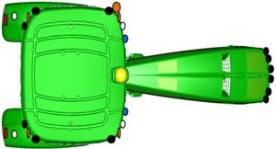 Standard lighting (8R)
Standard lighting (8R)
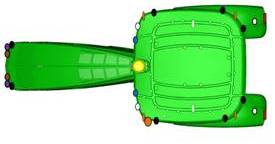 Standard lighting (7R)
Standard lighting (7R)
Six front grill-mounted lights:
- Two 65-W low-beam driving/work lights (mid grill screen)
- Two 65-W high-beam driving/work lights (top of grill screen, hood mounted)
- Two front corner-facing halogen work lights (top of grill screen, hood mounted)
10 cab roof-mounted lights:
- Two rear-facing 65-W floodlights
- Four side-facing 65-W floodlights
- Four corner-facing amber lights
Other lights:
- Two rear fender-mounted floodlights
- Two rear turn signal and brake/tail lights (fender mounted)
- Two folding-extremity lights
Plus these lights:
- Two adjustable front roof 65-W halogen floodlights
- Two front belt-line floodlights
- Rotary beacon light
Premium lighting
Eight front grill-mounted lights:
- Two 65-W low-beam halogen driving/work lights (mid grill screen)
- Two LED high-beam driving/work lights (top of grill screen, hood mounted)
- Two front corner-facing LED work lights (top of grill screen, hood mounted)
- Two front-facing LED working lights (top of grill screen, hood mounted, inner position on the sides)
12 cab roof-mounted lights:
- Four side-facing LED lights
- Four corner-facing amber lights
- Two rear-facing LED lights
- Two adjustable front roof LED lights
Other lights:
- Two rear fender-mounted LED lights
- Two rear turn signal and brake lights (fender mounted)
- Two folding-extremity lights
- Two front belt-line LED floodlights
- Rotary beacon light
The premium lighting package replaces all previous halogen and HID lights with LED lights. The only lights that are not LED are the low-beam driving lights, they remain halogen. This allows each LED light to work at a lower temperature and no one light works harder than any other. The uniformity in LED coverage allows only one type of light output surrounding the tractor.
The lighting pattern in the premium package provides industry-leading performance in nighttime visibility. LED bulbs provide maximum brightness and a true color output for excellent field definition that is easy on the operator's eyes.
The LED lights provide 40 percent greater coverage width and 10 percent more light coverage in the rear. LED lighting packages use 45 percent less amps than standard halogen lights and have an increased life expectancy over HID lights which leads to lower costs of ownership over the life of the tractor.
NOTE: Lighting packages may vary depending on region.
Selecting a lighting mode/programmable lighting
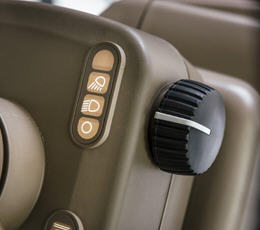 Lighting mode selector
Lighting mode selector

Operators can quickly select a lighting mode on the steering console:
- Lights, off position
- Road lights
- Field lights
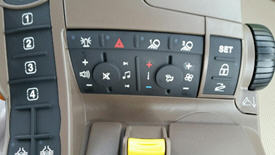 The CommandCenter™ display
The CommandCenter™ display
The CommandCenter display allows operators to customize light settings. Operators can select only the lights they need or want for a given application and store these settings. The operator-programmed configurations can then be turned on or off with the push of a button on the CommandARM™ controls.
- Programmable field lights 1
- Programmable field lights 2
- Beacon light
- Emergency flashers
NOTE: Road/loader lights are also referred to as high-mounted driving lights for use in front hitch applications that obscure the headlights. See the Attachments section.
The battery power saver feature is also standard. When the engine is off and the outside lights have been left on, this feature is designed to avoid battery run down.
After the lights have been left on for 30 minutes and the key is in the off position, the lights cycle or blink on and off five times as an alert. The lights continue to illuminate for one more minute and then automatically shut off to protect the battery.
Programmable exit lighting
Another feature is programmable exit lighting. Exit lighting allows the lights outside the cab to stay on for up to 300 seconds. They can be programmed in increments from 0 to 300 seconds.
Refer to the operator’s manual for complete instructions on programming field, driving, and exit lighting.
Field-installed options
Field-installed options are also available. To find this information, use the Build Your own Configurator application for US/Canada or Build & Price in John Deere Sales Centre for Australia/NZ.
| Option code | Description |
| 7201 | Standard lighting |
| 7206 | Premium lighting |
ActiveCommand steering (ACS™) provides a robust and full-encompassing steering system
ACS overview
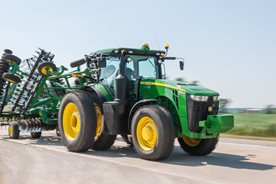 8R in transport
8R in transport

With ACS, John Deere has designed one of the most robust and full-encompassing steering system in the industry. Whether in the field or on the road, ACS reduces steering effort, which can result in reduced operator fatigue and can improve operator comfort.
There are four key features of the ACS system:
Dynamic road wheel offset:
- A gyroscope senses tractor yaw and can automatically make small steering adjustments to provide unprecedented line-holding abilities. Drive down a bumpy road and experience how ACS makes it easier to keep the tractor straight, even over rough terrain. ACS delivers the ultimate in comfort.
- ACS works to prevent over-steering when a sudden obstacle causes the operator to make a quick steering reaction.
Variable ratio steering:
- Approximately 3.5 turns lock-to-lock at in-field speeds for quick headland turns.
- Approximately 5 turns lock-to-lock at transport speeds.
Elimination of steering slop and hand wheel drift:
- Steering wheel drift and slop are eliminated with the ACS electronic control system.
Variable effort steering:
- Steering wheel resistance automatically changes with ground speed to deliver light steering effort at slower speeds for less effort during headland turns, and higher steering wheel torque at transport speeds for better comfort.
A fail operational system
The ACS system is fail operational, which means steering is still functional in the event of any single-point failure. John Deere has gone to great lengths to help ensure the operator has the ability to steer the tractor if something goes wrong in the steering system.
For example, if the primary controller fails, a second controller takes over. If power from the alternator fails, the battery resumes control. If the engine quits running and is unable to supply hydraulic oil to the system, an electric-driven backup pump is used to supply the oil. There is a backup for ACS components.
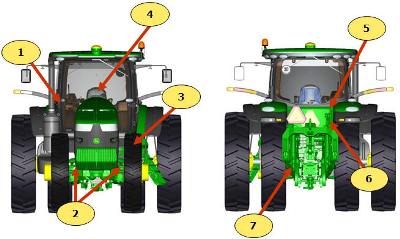 ACS components
ACS components

The ACS system consists of several key components:
- Gyroscope: this is used to measure the yaw rate (turn rate) of the tractor during transport speeds.
- Road-wheel angle sensors: these sensors simply measure the steer angle of the tractor.
- Power supply module: this module distributes the power of the battery and alternator throughout the ACS system.
- Hand-wheel angle sensors and tactile feedback unit: this includes the steering wheel position sensors and a brake which can increase or decrease resistance dependent on speed. Lighter feedback is desired during normal field use, and slightly heavier feedback is desired during transport and while the tractor is cornering at high speeds.
- Controllers: two controllers are located in the back of the tractor and are the brains of the system.
- Control valves: also known as steering valves, control valves are used to steer the tractor.
- Electric-drive backup pump: this pump supplies oil to the steering system, brakes, and park (for towing) brake if there is no longer a sufficient oil supply to the steering and brakes.
Value of ACS
- Improves line holding when driving at transport speeds
- Fewer turns lock-to-lock: 3.5 turns lock-to-lock in the field for quicker headland turns and 5 turns lock-to-lock at transport speeds
- Eliminates hand wheel backlash and drift
- Reduces steering effort results in reduced operator fatigue
- Smaller hand-wheel diameter for improved operator comfort and visibility
- Maintains operator feel and touch-points of traditional steering column system
- Fully integrates with AutoTrac™ guidance assisted steering stems
- Compatible with suspended and non-suspended front axles
- Compatible with wide and narrow section width tires
Independent-Link Suspension (ILS™) utilizes industry-leading technology
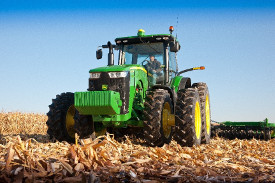 8R Series Tractor equipped with ILS
8R Series Tractor equipped with ILS
 Close-up view of ILS design
Close-up view of ILS design
The John Deere ILS utilizes industry-leading technology to supply unsurpassed gains to end-user productivity. This innovative design incorporates proven suspension design with mechanical front-wheel drive (MFWD) axle components that use state-of-the-art technology specifically for heavy equipment usage.
The ILS front axle is available on all 8R Series Tractor models.
42-km/h (26-mph) and 50-km/h (31-mph) front axles
Feature |
ILS |
Hydraulic differential lock |
Yes |
Limited slip |
No |
Suspension |
Yes |
Brakes |
Yes (optional on 42 km/h [26 mph]) |
Tire ratio/steps allowed |
5 or 6 |
Duals |
Yes |
Tread spacing singles* |
1574 mm - 2184 mm |
Tread spacing singles |
1524 mm - 2235 mm |
Singles with duals |
1524 mm - 2235 mm |
Duals |
2946 mm - 3658 mm |
Top speed |
42 km/h (26 mph) or 50 km/h (31mph) depending on model |
Front power take-off (PTO) |
Optional |
* Based on wheel equipment shipped to some geographic regions.
The ILS system gets more power to the ground because the front tires maintain ground contact pressure. This improves field and transport ride plus increases ballasting flexibility and drastically decreases the tendency to power hop.
 ILS cutaway
ILS cutaway
The ILS axle maintains minimum oil levels in the front differentials to assist in providing overall tractor operating efficiency.
John Deere ILS has three systems:
- A mechanical system
- A hydraulic system
- An electrical system
Mechanical system
The mechanical system is further broken down into the mechanical drive system and mechanical suspension system.
The mechanical drive system includes:
- A three-position switch is included on a MFWD clutch.
- The MFWD clutch has six clutch discs and separator plates that can transfer as much as 40 percent of the tractor power through to the front ILS axle.
- The front differential transfers power from the engine to the individual right and left driveshaft through a ring and pinion.
- A hydraulically engaged front differential lock containing eight clutch discs and eight separator plates works in conjunction with the rear differential lock to assist the tractor in tough, wet conditions with increased power transfer to all wheels.
- A right and left constant-velocity telescoping driveline provides smooth power transfer to the outboard hubs.
- On 8245R, 8270R, 8295R, and 8320R Tractors, the ILS driveshaft speed is 6:1. On 8345R, 8370R, and 8400R Tractors, the ILS driveshaft ratio is 8:1. By using an 8:1 ratio on higher horsepower tractors, power can get to the wheels while minimizing the torque the U-joint experiences.
The mechanical suspension system consists of large cast, upper- and lower-control arms with cast steering knuckles for durability and reliability.
- There is a high steering capacity, even with dual wheels – 25 percent increase over model year 2013
- High torque in all steering positions provides maximum transfer of power to the wheels under all conditions
- Fully independent suspension maintains optimum ground contact at all times
Hydraulic system
The hydraulic system consists of suspension cylinders, a control valve manifold, a front differential lock, and hydraulic accumulators.
- There is a high steering capacity through large steering cylinders.
- Responsive link arms maintain contact with the ground surface, giving maximum tractive performance under any condition.
- Accumulators dampen energy from bumps to produce a smooth ride for maximum operator comfort.
Electrical system
The electrical system contains position sensors, solenoids for the control valves, and a master controller for complete automatic control of the ILS system.
How does it work?
The mechanical, hydraulic, and electrical systems work together to maintain a level and vertically-centered position of the front differential case in relation to the outboard hubs and planetaries, independent of tractor weight or dynamic loading. The system's ability to maintain a vertically centered position provides full suspension travel of 25.4 cm (10 in.). This translates to consistent soil contact for improved power to the ground as well as dampens the energy from bumps that cause a rough ride.
The tractor utilizes electronic and computer controls that monitor tractor functions and axle position. Based on those inputs, the electrical system automatically triggers hydraulic functions to raise, lower, or remain static.
The John Deere ILS uses a short/long A-arm design, which means the upper control arms are shorter than the lower control arms. During wheel movement, the upper control arm moves in a smaller arc than the lower control arm, and the difference in the two arcs creates a change in camber. The change in camber helps keep the inside and outside of the front tires perpendicular to the drive surface, a very important feature when optional front dual wheels are installed. This design provides anti-dive characteristics to naturally reduce the adverse effects of braking and acceleration.
The John Deere ILS front axle has been specifically designed to accommodate additional options, such as front 3-point hitches and front duals. To properly handle these options, large steering cylinders and knuckles provide up to twice the steering capacity of the standard MFWD beam axles so steering performance is maintained. A simple steering stop arrangement offers infinite adjustability for fine-tuning in any row spacing.
Braking system
With higher speeds and expected heavy towed implements and carts, front brakes are optional on 42-km/h (26-mph) ILS-equipped tractors and part of base equipment on 50-km/h (31-mph) ILS-equipped tractors. The braking system is applied proportionally between the front and rear axle brakes to effectively stop the tractor. There are no operator adjustments or requirements to operate the additional braking system.
Tire compatibility
For travel speeds of 50 km/h (31 mph), B-speed-rated tires that provide high-speed capabilities are required.
With the ability to have a six-step drop from rear to front tire, the 8R equipped with an ILS axle is able to have group 49 rear tires with group 43 fronts. This allows for the benefits of group 49 tires while maintain the turning radius allowed by group 43 front tires.
NOTE: The use of group 44 tires for front duals does not allow for some row crop spacings.
Front duals
 8R Series Tractor with front duals
8R Series Tractor with front duals
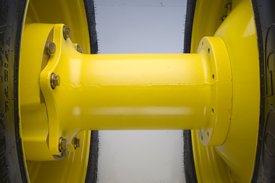 Narrow-diameter extension and hub attachment
Narrow-diameter extension and hub attachment
Front dual tires provide:
- Ultimate flotation and compaction management
- Increased load-carrying capacity
- Easy installation or removal; no need to remove the inner tire
- Bolt-on components versus studded flanges for superior flexibility for dual/no dual applications.
- Narrow hub extensions to ensure superior crop clearance for row crop applications
- A serviceability port has been added to eliminate the need to remove the front dual and hub in order to change the hub oil at the required service interval
Hitch application
In hitch applications, it is important to maintain at least 50 percent of the ballasted front-axle weight (with implement raised) for steering control. Referring to the example below, the maximum ballasted weight of the front axle is 7756 kg (17,100 lb). If the tractor has a hitch-mounted implement, when the tractor is weighed with the hitch and implement fully raised, the front weight must be at least 3878 kg (8550 lb). The front axle capacity is directly proportional to the weight that can be carried on the hitch.
The MFWD axle has a front weight carrying capacity equal to the front tire carrying capacity. For example, in row-crop applications using the popular 480/70R34 (155 load index) front tires, the highest load rating is 3878 kg (8550 lb) per tire with a total of 7756 kg (17,100 lb) at maximum tire pressure. This means (depending on tire pressure and speed) there is as much as 3878 kg (8550 lb) available for support of rear implements in transport.
Maximum load carrying capacity of the axle is determined by the load carrying capacity of the tires and whether the tractor is equipped with singles or duals.
Additional ILS features:
There is no on/off switch for ILS operation since the John Deere advanced electronic management system knows when to disengage ILS automatically. The electronic controller will activate a restricted mode of operation, when any of the following conditions are met:
- Both brake pedals are pushed
- The 3-point hitch raise/lower switch is activated
- The tractor is placed in park
- Wheel speed is less than 0.5 km/h (0.3 mph)
- Tractor is correcting for an out-of-level condition
Based on the inputs received (speed, suspension displacement, braking and operator input to hitch and/or remote cylinders), the tractor determines when the system should be active or inactive, making operation simple and efficient.
MFWD CommandARM™ controls for ILS
Shortcut keys on the CommandARM enable the operator to engage or disengage MFWD on the go, even under full load, without stopping or clutching. The switch can be placed in one of the following positions:
1. AUTO
2. On
3. Off (brake assist)
Mode 1 - AUTO
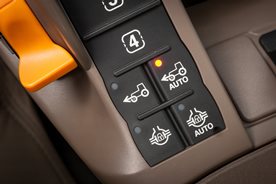 AUTO light
AUTO light
When this light-emitting diode (LED) light is lit, MFWD is on but automatically disengages when either of the following conditions are met:
- Either brake pedal is depressed and held to allow tighter turns
- Transporting at speeds above approximately 23.0 km/h (13.8 mph) to reduce tire wear; automatically engages when speed drops below 19.0 km/h (11.4 mph)
- When the front wheel turn angle meets an operator-defined point
As with the brake-assist position, when both brakes are depressed, the MFWD automatically engages (if not already on) to provide four-wheel braking.
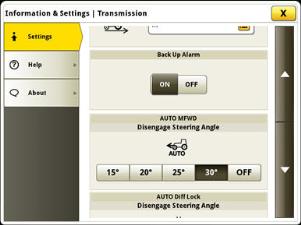 Automatic MFWD angle adjustment
Automatic MFWD angle adjustment
Mode 2 - MFWD on
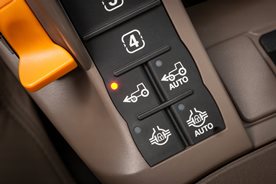 MFWD light
MFWD light
When this LED light is lit, MFWD engages continuously.
Mode 3 MFWD off (brake assist)
When no LED lights are lit, the MFWD is off. This is also referred to as the brake-assist position. Even though the MFWD is disengaged, when both brakes are pressed at speeds above 5 km/h (3 mph), the MFWD engages to assist braking the tractor.
Differential lock
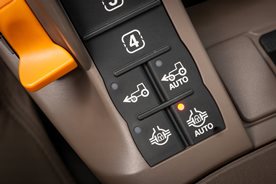 CommandARM™ controls with automatic differential lock engaged
CommandARM™ controls with automatic differential lock engaged
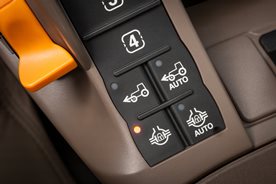 CommandARM controls with manual differential lock engaged
CommandARM controls with manual differential lock engaged
The differential lock is another feature of the ILS axle. When the rear differential lock is engaged or disengaged, the front differential lock is also engaged or disengaged. This also includes a driveline shield.
If one wheel begins to slip, the differential lock can be engaged on the go and the axles are hydraulically locked together for maximum traction. There are two ways to engage the differential lock feature.
- Manual differential lock - differential lock can be engaged manually using a switch on the floor or by manually depressing a button on the CommandARM console. When brakes are depressed, the differential lock will disengage
- Automatic differential lock - when in auto mode, differential lock is engaged when the tractor is driving forward. Differential lock will disengage when front wheel turn angle meets disengage wheel angle setting defined by the operator via the CommandCenter or when either brake pedal is depressed. Differential lock will automatically engage when brakes are released or front wheels are turned straight.
 Automatic differential lock angle adjustment
Automatic differential lock angle adjustment
Additional equipment for use with ILS axle
- 3M front axle spacing kit:
Front axle static weight for the ILS axle shall not exceed 6759 kg (14,900 lb) using the 3M kit - H480 Front Loader
Refer to the material handling section for additional information.
Hydraulic pump options to meet varying flow requirements
All 8R and 8RT Series Tractors come standard with an 85-cc displacement integrated hydraulic pump. This pump provides 227.1 L/min (60 gpm) of hydraulic flow.
A dual-pump option, featuring 85-cc and 35-cc displacement hydraulic pumps, is available for all 8R wheel models. The dual-pump system provides a hydraulic flow of 321 L/min (85 gpm), ideal for running at lower engine speeds.
SCV flow (approximate) |
||
Engine rpm |
Pump flow (85-cm3 pump) L/min (gpm) |
High pump flow (85-cm3 pump + 35-cm3 optional pump) L/min (gpm) |
800 |
86 (23) |
122 (32) |
1500 |
162 (43) |
229 (61) |
1700 |
184 (49) |
260 (69) |
1900 |
206 (54) |
290 (77) |
2100 |
227 (60) |
321 (85) |
Operating the tractor at reduced engine rpm contributes to a quieter cab, reduced fuel usage, and maintains the vacuum while turning and raising the planter on end rows. At 1500 erpm with a 321 L/min (85 gpm) system there will be an available flow of 229 L/min (61 gpm). This is an improvement over an available 162 L/min (43-gpm) flow when operating with a 227 L/min (60 gpm) system at 1500 erpm.
The maximum flow through one selective control valve (SCV) with a standard coupler is 132 L/min (35 gpm). A 19.1-mm (3/4-in.) high-flow coupler allows for a maximum flow rate out of one SCV of 153 L/min (40.5 gpm).
The hydraulic system is a closed-center, power-on-demand system using a load-sensing pressure-flow compensated axial piston pump with full-flow charge and flow prioritization for steering and brakes.
The pump outlet pressure available on demand can range from 3000 kPa (435 psi) for track models and 4000 kPa (580 psi) for wheel models at low standby to 20,400 kPa (2958 psi) at high standby.
Hydraulic pump options:
- 85-cc displacement, 227-L/min (60-gpm) hydraulic pump
- NOTE: Standard on all 8R models.
- 85-cc and 35-cc dual pump option, 321-L/min (85-gpm)
- NOTE: Compatible with 2014 Final Tier 4 (FT4) and newer 8R Wheel Tractors only.
Standard CommandView™ III cab offers unsurpassed amenities
 CommandView III cab
CommandView III cab
The Standard CommandView III cab offers unsurpassed visibility, operator comfort, control placement, and ride and sound quality.
Features:
- ComfortCommand™ seat with air suspension, lumbar support, swivel, fore-aft and lateral attenuation, backrest angle adjustment, adjustable left-hand armrest, and 40-degree right-hand seat swivel
- Operator presence system that warns if the operator is out of the seat while operating key functions
- Folding instructional seat
- CommandARM™ console with integrated controls
- 4100 or 4600 Generation 4 CommandCenter™ display
- Behind-the-seat storage
- Left-hand storage compartment
- Passive noise reduction system
- Service ADVISOR™ data port
- Tilt/telescoping steering wheel with position memory
- Swing-out rear window that opens 30 degrees
- Right- and left-outside mirrors (manually adjustable mirror head)
- Monitor mounts on right-hand front post and rear cab post
- Standard radio package, including AM/FM stereo and weatherband with remote controls, auxiliary input jack, four speakers, and an external antenna
- Laminated glass
- Air conditioner and heater with automatic temperature controls (ATC)
- Two 12-V convenience outlet (cigarette lighter style)
- One 12-V three-pin outlet with adapter (provides switched and unswitched power)
- One International Organization for Standardization (ISO) nine-pin connector
- Power strip with convenience plug adapter
- Hitch control lever lock and selective control lever lock
- Two-speed and intermittent front and rear wiper with washer
- Front pull-down sunshade
- Digital cornerpost display with:
- Fuel level gauge, including low fuel warning
- Temperature gauge
- Diesel exhaust fluid (DEF) gauge, including low DEF warning
- Engine rpm
- Transmission commanded gear or speed
- Vehicle system functions, such as iTEC™ system, that are operating
- Inside-mounted rearview mirror
- Beverage holders sized to accommodate various containers
- Interior left-hand dome light
ComfortCommand seat
 ComfortCommand seat
ComfortCommand seat
ComfortCommand seat improves ride quality and helps to reduce operator fatigue.
Features include:
- Armrests, lumbar support, and backrest angle are easily adjusted to match operator preference.
- Shock absorbers dampen the motion effect of the tractor for an improved ride.
- Seat height adjustments are conveniently located on the left armrest.
- Fore-aft adjustment is easy to reach located on the left front of the seat.
- Swivel adjustment, located on the front of the seat, allows the seat to be swiveled 40 degrees to the right or eight degrees to the left of the center position.
- Operator presence switch warns if the operator is out of the seat while operating key functions.
- Seat belt retractor.
- Centered cab seat provides excellent over-shoulder visibility.
- Adjustable shock absorber permits ride adjustment from soft to firm to match the operator's desired comfort level.
- Removable cushions allow for easy cleaning.
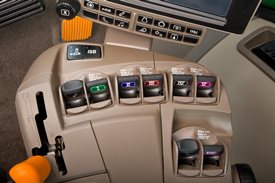 Fingertip paddle pots
Fingertip paddle pots
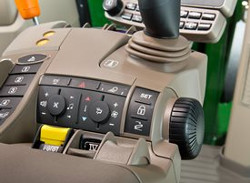 Encoder wheel
Encoder wheel
CommandARM
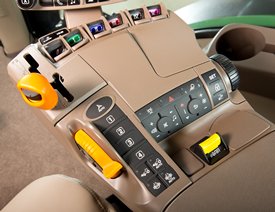 CommandARM controls
CommandARM controls
John Deere 7R and 8R Series Tractors feature the CommandARM with integrated Generation 4 CommandCenter display. The control layout of the CommandARM utilizes a clean and efficient design which groups controls by function and builds upon John Deere’s history of intuitive and ergonomic control placement and operation. The design of the CommandARM allows for a 40 degree right seat swivel and adjustable positioning matching the operator’s preference.
Controls located on the CommandARM include:
- Engine throttle
- FieldCruise™ system
- Minimum engine speed – CommandQuad™ transmission, 16-speed PowerShift™ transmission (PST), e23™ transmission
- Eco mode – Infinitely Variable Transmission (IVT™)
- Foot pedal lock (if equipped)
- Transmission control
- Hitch/selective control valve (SCV) controls
- Rotary encoder hitch control
- Power take-off (PTO) controls
- Mechanical front-wheel drive (MFWD) on/automatic
- Differential lock on/automatic
- iTEC sequence switches
- AutoTrac™ assisted steering system resume switch (if equipped)
- Joystick (if equipped)
- Radio
- Beacon light on/off
- Hazard lights on/off
- Field lights 1/2
- Heating, ventilation, air conditioning (HVAC) system
Transmission controls
John Deere 7R Series Tractors with CommandQuad transmissions feature a left-hand reverser. 8R Series Tractors equipped with 16-speed PST are equipped with right-hand reverser. 7R Series Tractors equipped with e23 PST offer a left- or right-hand reverser. 7R or 8R Series Tractors equipped with AutoPowr™/IVT transmissions are offered with either a left-hand or a right-hand reverser.
The transmission control lever is placed on the left side of the CommandARM closest to the operator for convenient setting and adjustment.
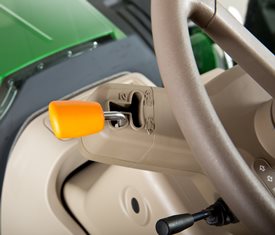 Left-hand CommandQuad/e23 reverser
Left-hand CommandQuad/e23 reverser
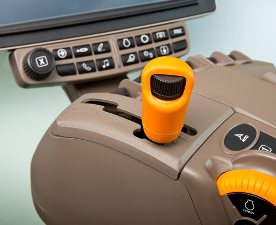 Right-hand IVT and PST reverser
Right-hand IVT and PST reverser
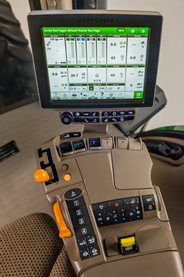 16-speed PST right-hand reverser
16-speed PST right-hand reverser
Hydraulic and hitch controls
Hydraulic and hitch controls utilize fingertip paddle pots for raise/lower and extend/retract functions. An optional crossgate joystick replaces fingertip paddle pots for control of SCVs and allows for programmable hydraulic functionality according to operator preference. Rear hitch position can also be controlled with the encoder wheel located on the right side of the CommandARM. The encoder wheel allows for finite positioning of the rear 3-point hitch.
Three buttons near the encoder are for hitch set, lock, and return to height. Adjustment knobs for the 3-point hitch are located under the cover for the CommandARM control's storage compartment and allow for adjustment of the rate of drop, hitch height limit, and depth control.
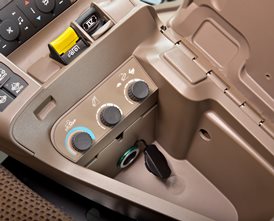 Hitch controls
Hitch controls
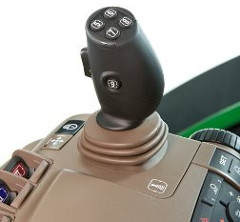 Optional crossgate joystick
Optional crossgate joystick
Throttle
The throttle design incorporates buttons which control FieldCruise speed, foot pedal mode (if equipped), and transmission eco settings.
 Throttle
Throttle
 Foot throttle
Foot throttle
Tractor function controls
Located just to the right of the throttle is the AutoTrac activation button and four sequence controls for iTEC functions. Behind the iTEC sequence controls, there are buttons which control the activation and deactivation of MFWD and differential lock.
 AutoTrac resume and iTEC strip
AutoTrac resume and iTEC strip
Controls for radio, lights, rotary beacon (if equipped), hazard flashers, and HVAC system are located to the center-right on the CommandARM, along with PTO for both front (if equipped) and rear PTO.
 Radio, HVAC, hazard flashers, and PTO controls
Radio, HVAC, hazard flashers, and PTO controls
Seat swivel
The design of the CommandARM allows for up to 40 degrees of right-hand seat swivel.
 Seat swivel
Seat swivel
CommandCenter
 Generation 4 CommandCenter
Generation 4 CommandCenter
The Generation 4 CommandCenter features fast adjustment of tractor functions and controls and are integrated into the CommandARM to create a seamless control center. The 4100 CommandCenter features a 178-mm (7-in.) touchscreen display and is standard equipment on 7210R and 7230R models, while the 4600 CommandCenter features a 154-mm (10-in.) touchscreen and is standard equipment on 7250R – 7310R models, as well as all 8R and 8RT models.
The following functions can be adjusted using the CommandCenter display:
- Hydraulic settings
- Hitch settings
- Transmission settings
- FieldCruise
- iTEC programming functions
- Radio
- Lights
Tire options for 8R Series Tractors
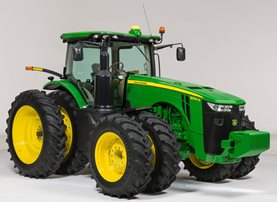

John Deere 8R Series Tractors are utilized in numerous applications that place different demands on tires. As such, multiple tire offerings are available for 8R Series Tractors to accommodate a wide range of grower needs. Tire options provide variability in terms of ground clearance, tread width, and floatation to match different operating conditions.
John Deere sources 8R Series Tractor tires from the following major brands:
- Mitas® tires
- Firestone® tires
- Goodyear® tires
- Michelin® tires
- Trelleborg® tires
Tire matching (rears and fronts)
 8R Series Tractor
8R Series Tractor

Front and rear tires for 8R Series Tractors are sized and combined under different group sizes based on tire rolling circumference. All front tire options for 8R Series Tractors are classified as group 42, 43, or 44, while all rear tires are classified as group 47, 48, or 49. The approximate overall diameters for each group are shown in the following table.
| Group | Overall diameter |
| 42 | 1498 mm (59 in.) |
| 43 | 1600 mm (63 in.) |
| 44 | 1676 mm (66 in.) |
| 47 | 1955 mm (77 in.) |
| 48 | 2057 mm (81 in.) |
| 49 | 2172 mm (85.5 in.) |
For tractors with mechanical front-wheel drive (MFWD) or Independent-Link Suspension (ILS™) front axles, there typically needs to be five steps (or group size difference) between the front and rear tires to maintain proper tire overspeed between axles. This means the group 42 front tire needs to be matched with group 47 rear tire, and group 43 front tire needs to be matched with group 48 rear tire.
On 1500 MFWD axles, four-step combinations between front and rear tires are also acceptable (determined at the time of ordering the tractor). This means group 44 front tire can be matched with group 48 rear tire, or group 43 front tire can be matched with group 47 rear tire. Six step combinations are possible on tractors equipped with ILS, allowing group 43 front tires to be paired with group 49 rear tires in order to maintain narrower tread functionality with row crop width tire options.
Additionally, tires have a load index rating designed to report the load carrying capability of the tire.
Group 49 rear tires


John Deere 8R Series Tractors are now approved for group 49 rear tires. Group 49 tires have a larger diameter and longer footprint, which results in greater traction in most field conditions compared to smaller group size tires of the same section width and basic design. Group 49 tires also provide a larger air volume than comparable smaller group sizes, which can help control power hop in some conditions.
NOTE:
- Front tread spacing for group 49 tires (group 44 fronts) has to be 1930 mm (76 in.) or wider based on tire size. For 762-mm (30-in.) tread spacings, tractors equipped with ILS may be equipped with group 49 rear tires and group 43 front tires.
- 710/75R42 (group 49) tires are available in singles only (see Configurator for complete offering)
- 480/95R50 (group 49) tires are available in duals only (see Configurator for complete offering)
- Operators will experience a decrease in turning radius with group 49 tires due to the larger-diameter group 44 front tires.
Row width guidelines
Multiple tire options are available for 8R Series Tractors to accommodate multiple applications or row widths. Refer to the minimum recommended row widths for tire options based on the row-width requirements in the following table.
NOTE: Not all tires listed in the chart are available on all John Deere tractors. See your local John Deere dealer for assistance in choosing the proper tires for specific tractor models.
Rear tires |
Minimum recommended row width |
|||||||
508 mm |
559 mm |
762 mm |
813 mm |
1016+ mm |
||||
Rear tire section width |
||||||||
RCI Group |
Approximate outside diameter |
320 mm |
380 mm |
480 mm* |
520 mm* |
620 mm |
710 mm (28.0 in.) |
800 mm (31.5 in.) |
49 |
2175 mm |
|
|
480/95R50 |
|
|
710/75R42 |
|
48 |
2057 mm |
320/105R54 |
380/90R54 |
480/80R50 |
520/85R46 |
620/70R46 650/85R38 |
710/70R42 |
800/70R38 |
47 |
1956 mm |
320/90R54 |
380/90R50 |
18.4R46 480/80R46 |
20.8R42 520/85R42 |
620/70R42 650/75R38 |
710/70R38 |
|
*480 and 520 width tires will accommodate minimum tread setting of 33 in. with 85L oil takeout.
Hitch clearance and tread spacing
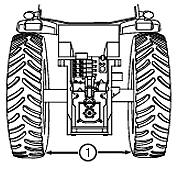 Tread spacing
Tread spacing

To prevent draft link interference, the distance (1) between the inside edges of the tires should be:
- Category 3N hitch – 1092 mm (43 in.)
- Category 3 hitch – 1168 mm (46 in.)
- Category 4N hitch – 1168 mm (46 in.)
* Tires 480 mm (19 in.) and larger may not be able to reach all tread settings. Refer to the operator’s manual for detailed tread setting limitations.
Goodyear is a trademark of Goodyear Tire and Rubber Company.
Firestone is a trademark of Bridgestone Americas Tire Operations, LLC.
Michelin is a trademark of MNA, Inc.
Mitas Tires North America is a registered subsidiary of MITAS a.s.
Trelleborg is a trademark of Trelleborg Wheel Systems, Inc.
| Front tires | Minimum recommended row width | |||||||
| 508 mm (20 in.) |
559 mm (22 in.) |
762 mm (30 in.) |
813 mm (32 in.) |
1016+ mm (40+ in.) |
||||
| Front tire section width | ||||||||
| RCI Group | Approximate outside diameter | 290 mm (11.4 in.) |
320 mm (12.6 in.) |
380 mm (15.0 in.) |
420 mm (16.5 in.) |
480 mm (18.9 in.) |
520 mm (20.5 in.) |
620 mm (24.4 in.) |
| 44 | 1676 mm (66 in.) |
540/75R34 | 620/75R30 | |||||
| 43 | 1600 mm (63 in.) |
320/80R42 | 380/80R38 | 420/85R34 | 480/70R34 | 540/65R34 | 600/70R30 | |
| 42 | 1499 mm (59 in.) |
320/85R38 | 380/85R34 | 16.9R30 420/90R30 |
480/70R30 | 540/65R30 | 600/65R28 | |
Please reference the operator’s manual for tread spacing requirements.
Rear power take-off (PTO) options
 45-mm (1-3/4-in.), 1000-rpm PTO
45-mm (1-3/4-in.), 1000-rpm PTO
All 8R and 8RT Series Tractors come standard with a fully independent 45-mm (1-3/4-in.), 1000-rpm PTO. This 20-spline shaft is designed for high-power, heavy PTO loads that require full horsepower above 150 PTO hp.
The 8R Series Wheel Tractors offer additional mechanical and electrical speed-change PTO options to provide the versatility and flexibility needed to satisfy implement demands. An in-cab shiftable, eco version of the 45-mm (1-3/4-in.), 1000-rpm PTO is available, allowing full PTO rotations at decreased engine speeds.
Additionally, a 45-mm (1-3/4-in.), 1000-rpm PTO capable of 35 mm (1-3/8 in.), 540-rpm (6 spline)/1000-rpm (21 spline) can be ordered. To field convert to the 35-mm (1-3/8-in.) 540/1000-rpm PTO, a field kit is required (the required shaft is dependent on the hitch option).
NOTE: 540-rpm PTO options are not compatible with the Category 4 drawbar.
The PTO activation switch is located on the CommandARM™ controls. In addition, PTO engagement modulation is adjustable with settings located in the CommandCenter™ display. The PTO shaft can be slightly rotated or indexed to aid in PTO drive hookups. All PTO options feature internal lubrication with heavy-duty oil-cooled clutch plates. A PTO safety start system and seat-activated PTO warning is standard on all 8R and 8RT Series Tractors.
The following tables show when shaft kits are required for each PTO shaft based on the selected hitch option (drawbar, 3-point hitch, 80-mm ball/piton).
1000/540 PTO |
||||||
| PTO type | Nominal diameter, mm | Number and type of splines | PTO speed (rpm) | Drawbar | 3-point hitch | 80-mm ball/piton |
| 1 | 35 | 6 straight splines | 540 | RE272736 | RE272736 | R538037 |
| 2 | 35 | 21 involute splines | 1000 | RE272736 | RE272736 | R537791 |
| 3 | 45 | 20 involute splines | 1000 | OK from factory | OK from factory | OK from factory |
1000/1000E PTO |
||||||
| PTO type | Nominal diameter, mm | Number and type of splines | PTO speed, rpm | Drawbar | 3-point hitch | 80-mm ball/piton |
| 1 | 35 | 6 straight splines | 540 | No solution | No solution | No solution |
| 2 | 35 | 21 involute splines | 1000/1000E | R537790 | R537790 | R313423 |
| 3 | 45 | 20 involute splines | 1000/1000E | OK from factory | OK from factory | OK from factory |
General applications:
- Use the 45-mm (1-3/4-in.), 1000-rpm PTO for full-power PTO applications, such as grain carts, rotavators, and silage choppers.
- Use the 35-mm (1-3/8-in.), 1000-rpm PTO shaft on implements requiring less than 150 PTO hp, such as manure spreaders and rotary cutters.
- Use the 35-mm (1-3/8-in.), 540-rpm PTO shaft on implements requiring less than 75 PTO hp (light loads only), such as auger applications.
NOTE: Proper engine speed for the 1000-rpm PTO shaft is 2000 engine rpm. For the 540-rpm PTO shaft, proper engine speed is 1817 rpm.
Rear PTO options:
- 45-mm (1-3/4-in.), 1000-rpm (20-spline) PTO
- NOTE: Compatible with 8R and 8RT Series Tractors.
- 45-mm (1-3/4-in.), 1000-rpm (20 spline), capable of 35-mm (1-3/8-in.), 540-rpm (6-spline)/1000-rpm (21-spline) PTO
- NOTE: Compatible with 8R Wheel Tractors.
To field convert to 35-mm (1-3/8-in.), 540/1000-rpm PTO, a kit will be required.
35-mm (1-3/8-in.), 540-rpm PTO portion of this option is not compatible with the Category 4 drawbar.
- NOTE: Compatible with 8R Wheel Tractors.
- 45-mm (1-3/4-in.), 1000-rpm and 1000E economy rpm PTO, in-cab shiftable
- NOTE: Compatible with 8R Wheel Tractors only. Not compatible with 16-speed PowerShift™ transmission (PST).
Includes 45-mm (1-3/4-in.), 1000-rpm (20-spline) shaft. See Parts for additional bolt-on shafts.
- NOTE: Compatible with 8R Wheel Tractors only. Not compatible with 16-speed PowerShift™ transmission (PST).
ActiveSeat™ seat utilizes electrohydraulic technology with air suspension
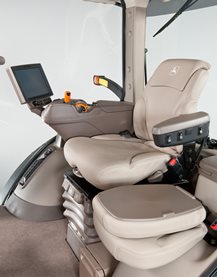 ActiveSeat and controls
ActiveSeat and controls

John Deere’s ActiveSeat utilizes electrohydraulic technology in combination with air suspension, providing the operator with enhanced ride quality over standard air-suspension seats.
Operator movements are monitored in order to reduce vertical movement. An ActiveSeat suspension can isolate the operator from up to 90 percent of vertical movements typically seen in tractor applications.
The system uses a hydraulic cylinder that is connected to a control valve assembly. Electrohydraulic valves located in the control valve assembly automatically react to inputs from two sensors, a position sensor and an accelerometer. Inputs from these two sensors control oil flow from the tractor to the hydraulic cylinder to reduce the vertical movement of the operator.
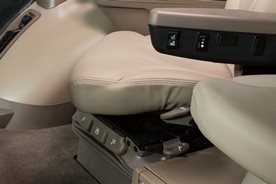 ActiveSeat left armrest
ActiveSeat left armrest

The John Deere ActiveSeat has many of the same features of the ComfortCommand™ seat with the addition of a ride firmness switch. The ride firmness switch is located on the left-hand armrest and replaces the suspension shock-dampening seat attenuation lever on the front right-hand side of the ComfortCommand seat controls.
The ride firmness switch has three positions: plus, minus, and mid position. The three positions provide three different levels of seat performance:
- The plus position provides the greatest degree of ride firmness. This position allows more of the tractor's inputs to be felt by the operator (slightly rougher ride).
- The minus position provides the least degree of ride firmness, allowing minimal tractor inputs to reach the operator, resulting in maximum seat performance.
- The mid position allows a balance between the plus (+) and minus (-) settings.
The ActiveSeat is also available as a heated leather seat for increased comfort and easier cleaning. For tractor applications where operating speed is not limited by the implement, the ActiveSeat can allow for faster field speeds and increased overall comfort and productivity.
NOTE: The John Deere ActiveSeat is not available on track tractors.
| Option code | Description |
| 2061 | Premium CommandView III Cab with Active Seat |
Take advantage of the Generation 4 CommandCenter™ display, designed for efficiency
The Generation 4 CommandCenter was designed to provide a consistent user experience by providing full-screen viewing of more run page modules, shortcut keys, and precision agriculture capabilities.
Expect easier set-up, along with increased operator confidence, thanks to a simple, customizable interface. The improved design of the Generation 4 CommandCenter also aids in an optimal operating experience and maximizes uptime.
In order to increase your efficiency, take advantage of the following features offered by the Generation 4 CommandCenter:
Layout manager
 Layout manager selection page
Layout manager selection page
 Layout manager module build
Layout manager module build
- Easily create page views that meet your needs and that are also equipped with default run pages.
- Users and access allow the owner or manager to lock out certain functions to prevent operators from accessing or changing settings with a defined four-digit code.
- Gather on-screen help by selecting the help icon on the shortcut bar on the bottom of every page.
Machine monitor
 Machine monitor page
Machine monitor page
- The Machine Monitor application provides you instantaneous readings about the status or condition of your machine.
- This application shows parameters such as engine speed, coolant temperature, and ground speed.
Work monitor
 Work monitor page
Work monitor page
- The Work Monitor application displays performance information about the task being performed by the machine.
- You are shown averages, totals, and productivity of the machine, such as area worked, average working speed, and fuel usage.
- Work setup places the settings needed to properly setup features such as AutoTrac, Documentation, and Section Control in a single location. Settings include:
- Client, farm, and field
- Crop type
- Machine and implement dimensions
- Variety/hybrid and planting/seeding rates
- Variable rate prescriptions
- Product and application rates
- Application rates through the implement screens
Video capability
- Machines equipped with a 4200 CommandCenter are equipped with one video input, and the 4600 CommandCenter has four video inputs.
- You have the ability to set a variety of triggers. With each trigger, the image will then appear on the display.
Flags
 Create flags to mark items in the field
Create flags to mark items in the field
- Mark areas in the field that need special attention such as rocks, tile lines, or weed pressure.
- Flags previously recorded on the Gen 4 or GreenStar™ 3 2630 Display can be transferred between monitors.
- Flags previously recorded on the Gen 4 or GreenStar™ 3 2630 Display can be transferred between monitors.
Field boundaries
 Boundary creation from coverage
Boundary creation from coverage
 Headland creation
Headland creation
- Manually drive field boundaries with the Generation 4 CommandCenter or import existing boundary information from the GreenStar 3 2630 Display or John Deere Operations Center. Gen 4 documentation data can be used to create boundaries from coverage within the John Deere Operations Center.
Dual-display mode
 Dual display
Dual display
- Generation 4 CommandCenter may be configured to run with the following John Deere displays connected at the cornerpost of a John Deere tractor:
- GreenStar 2 1800 Display
- GreenStar 2 2600 Display
- GreenStar 3 2630 Display
- 4640 Universal Display
- 4240 Universal Display
NOTE: Vehicle applications will always be located on the Gen 4 CommandCenter.
Automatic base station switching
 Setup base stations in Fields and Boundaries applications
Setup base stations in Fields and Boundaries applications
- Customers using John Deere RTK Radio 450 or 900 can link a base station to a desired client,/ farm,/ or field. This allows automatic switching to the associated base station when changing fields. The ability to import base station assignments into Operations Center and send back to machines will be available at a later date.
Video looping supported with Gen 4 4600 CommandCenter Display and 4640 Universal Display
 Scan through videos with video looping
Scan through videos with video looping
- This feature enables users to scan or loop through all of the available video feeds for a specified duration. The default scan time is set to 7 seconds per image. The scan time is customizable per image allowing for consistent visibility to all video feeds.
Features
Lighting packages provide 360 degrees of coverage for maximum productivity
 Premium lights
Premium lights

The 7R, 8R, and 8RT Series Tractors feature two lighting package options:
- Standard
- Premium
The cab lighting pattern provides 330 degrees of coverage while the hood lighting provides the remaining 30 degrees for completely programmable 360-degree, stadium-style lighting. This ensures there are no dead zones or lighting adjustments needed. The lighting configurations are available to match various applications and ensure maximum around-the-clock productivity.
Bulb housings are large, allowing for optimum total lumens and available light. The standard lighting packages use 65-W halogen bulbs, whereas the premium lighting package uses light-emitting diode (LED) lights. In the premium lighting package, these tractors take advantage of the high-performing and efficient LED technology.
The low- and high-beam driving/work lights are adjustable. Please refer to the electrical section in the operator’s manual for complete details on adjusting lights.
 7R/8R/8RT lighting
7R/8R/8RT lighting

Yellow circles
- All lighting packages: 65-W halogen: road low beam
Red circles
- Standard: 65-W halogen
- Premium: LED
Blue circles
- Standard: 65-W halogen; field and road high beams
- Premium: LED
Orange circles
- Standard: blank
- Premium: LED
|
Standard lighting
 Standard lighting (8R)
Standard lighting (8R)
 Standard lighting (7R)
Standard lighting (7R)
Six front grill-mounted lights:
- Two 65-W low-beam driving/work lights (mid grill screen)
- Two 65-W high-beam driving/work lights (top of grill screen, hood mounted)
- Two front corner-facing halogen work lights (top of grill screen, hood mounted)
10 cab roof-mounted lights:
- Two rear-facing 65-W floodlights
- Four side-facing 65-W floodlights
- Four corner-facing amber lights
Other lights:
- Two rear fender-mounted floodlights
- Two rear turn signal and brake/tail lights (fender mounted)
- Two folding-extremity lights
Plus these lights:
- Two adjustable front roof 65-W halogen floodlights
- Two front belt-line floodlights
- Rotary beacon light
Premium lighting
Eight front grill-mounted lights:
- Two 65-W low-beam halogen driving/work lights (mid grill screen)
- Two LED high-beam driving/work lights (top of grill screen, hood mounted)
- Two front corner-facing LED work lights (top of grill screen, hood mounted)
- Two front-facing LED working lights (top of grill screen, hood mounted, inner position on the sides)
12 cab roof-mounted lights:
- Four side-facing LED lights
- Four corner-facing amber lights
- Two rear-facing LED lights
- Two adjustable front roof LED lights
Other lights:
- Two rear fender-mounted LED lights
- Two rear turn signal and brake lights (fender mounted)
- Two folding-extremity lights
- Two front belt-line LED floodlights
- Rotary beacon light
The premium lighting package replaces all previous halogen and HID lights with LED lights. The only lights that are not LED are the low-beam driving lights, they remain halogen. This allows each LED light to work at a lower temperature and no one light works harder than any other. The uniformity in LED coverage allows only one type of light output surrounding the tractor.
The lighting pattern in the premium package provides industry-leading performance in nighttime visibility. LED bulbs provide maximum brightness and a true color output for excellent field definition that is easy on the operator's eyes.
The LED lights provide 40 percent greater coverage width and 10 percent more light coverage in the rear. LED lighting packages use 45 percent less amps than standard halogen lights and have an increased life expectancy over HID lights which leads to lower costs of ownership over the life of the tractor.
NOTE: Lighting packages may vary depending on region.
Selecting a lighting mode/programmable lighting
 Lighting mode selector
Lighting mode selector

Operators can quickly select a lighting mode on the steering console:
- Lights, off position
- Road lights
- Field lights
 The CommandCenter™ display
The CommandCenter™ display
The CommandCenter display allows operators to customize light settings. Operators can select only the lights they need or want for a given application and store these settings. The operator-programmed configurations can then be turned on or off with the push of a button on the CommandARM™ controls.
- Programmable field lights 1
- Programmable field lights 2
- Beacon light
- Emergency flashers
NOTE: Road/loader lights are also referred to as high-mounted driving lights for use in front hitch applications that obscure the headlights. See the Attachments section.
The battery power saver feature is also standard. When the engine is off and the outside lights have been left on, this feature is designed to avoid battery run down.
After the lights have been left on for 30 minutes and the key is in the off position, the lights cycle or blink on and off five times as an alert. The lights continue to illuminate for one more minute and then automatically shut off to protect the battery.
Field-installed options
Field-installed options are also available. To find this information, use the Build Your own Configurator application for US/Canada or Build & Price in John Deere Sales Centre for Australia/NZ.
Programmable exit lighting
Another feature is programmable exit lighting. Exit lighting allows the lights outside the cab to stay on for up to 300 seconds. They can be programmed in increments from 0 to 300 seconds.
Refer to the operator’s manual for complete instructions on programming field, driving, and exit lighting.
| Option code | Description |
| 7201 | Standard lighting |
| 7206 | Premium lighting |
ActiveCommand steering (ACS™) provides a robust and full-encompassing steering system
ACS overview
 8R in transport
8R in transport

With ACS, John Deere has designed one of the most robust and full-encompassing steering system in the industry. Whether in the field or on the road, ACS reduces steering effort, which can result in reduced operator fatigue and can improve operator comfort.
There are four key features of the ACS system:
Dynamic road wheel offset:
- A gyroscope senses tractor yaw and can automatically make small steering adjustments to provide unprecedented line-holding abilities. Drive down a bumpy road and experience how ACS makes it easier to keep the tractor straight, even over rough terrain. ACS delivers the ultimate in comfort.
- ACS works to prevent over-steering when a sudden obstacle causes the operator to make a quick steering reaction.
Variable ratio steering:
- Approximately 3.5 turns lock-to-lock at in-field speeds for quick headland turns.
- Approximately 5 turns lock-to-lock at transport speeds.
Elimination of steering slop and hand wheel drift:
- Steering wheel drift and slop are eliminated with the ACS electronic control system.
Variable effort steering:
- Steering wheel resistance automatically changes with ground speed to deliver light steering effort at slower speeds for less effort during headland turns, and higher steering wheel torque at transport speeds for better comfort.
A fail operational system
The ACS system is fail operational, which means steering is still functional in the event of any single-point failure. John Deere has gone to great lengths to help ensure the operator has the ability to steer the tractor if something goes wrong in the steering system.
For example, if the primary controller fails, a second controller takes over. If power from the alternator fails, the battery resumes control. If the engine quits running and is unable to supply hydraulic oil to the system, an electric-driven backup pump is used to supply the oil. There is a backup for ACS components.
 ACS components
ACS components

The ACS system consists of several key components:
- Gyroscope: this is used to measure the yaw rate (turn rate) of the tractor during transport speeds.
- Road-wheel angle sensors: these sensors simply measure the steer angle of the tractor.
- Power supply module: this module distributes the power of the battery and alternator throughout the ACS system.
- Hand-wheel angle sensors and tactile feedback unit: this includes the steering wheel position sensors and a brake which can increase or decrease resistance dependent on speed. Lighter feedback is desired during normal field use, and slightly heavier feedback is desired during transport and while the tractor is cornering at high speeds.
- Controllers: two controllers are located in the back of the tractor and are the brains of the system.
- Control valves: also known as steering valves, control valves are used to steer the tractor.
- Electric-drive backup pump: this pump supplies oil to the steering system, brakes, and park (for towing) brake if there is no longer a sufficient oil supply to the steering and brakes.
Value of ACS
- Improves line holding when driving at transport speeds
- Fewer turns lock-to-lock: 3.5 turns lock-to-lock in the field for quicker headland turns and 5 turns lock-to-lock at transport speeds
- Eliminates hand wheel backlash and drift
- Reduces steering effort results in reduced operator fatigue
- Smaller hand-wheel diameter for improved operator comfort and visibility
- Maintains operator feel and touch-points of traditional steering column system
- Fully integrates with AutoTrac™ guidance assisted steering stems
- Compatible with suspended and non-suspended front axles
- Compatible with wide and narrow section width tires
Hydraulically actuated, power wet-disc brakes
The brakes are designed with large-diameter rear disc brakes and powerful activating pistons. The brakes run in oil for cooling and long life in the most demanding situations. Braking in the field during a turn can be accomplished with light pedal effort and excellent modulation of brake forces.
Hydraulically actuated, power wet-disc brakes:
- Never require adjustment
- Oil cooled for long life
- Tractors equipped with front brakes use annular pistons that automatically retract after each braking operation to reduce friction for better fuel economy
- Self-equalizing feature ensures even braking to each wheel
- Integrated backup braking capabilities built into the brake system to provide positive brake engagement should the engine or hydraulic system fail
- Brake valve is located externally of the cab to provide a quiet operating environment
An integrated park brake is included with all transmission options.
Front wet-disc brakes are included on 8R Series Tractors equipped with the 50-km/h (31-mph Independent-Link Suspension (ILS™) axle and 7R Series Tractors equipped with a 50-km/h (31-mph) Triple-Link Suspension (TLS™) Plus front axle. Front Brakes are optional equipment on the 8R 42-km/h (26-mph) ILS axle and 40-km/h (25-mph) TLS Plus front axles.
Foot brakes on tractors equipped with AutoPowr™/Infinitely Variable Transmission (IVT™) transmissions have an integrated AutoClutch™, as described in the IVT section. Similarly, foot brakes on tractors equipped with e23™ transmissions have integrated AutoClutch™, as described in the e23 section.
For towing very large loads, the 7R and 8R Series Tractors can be equipped with a complete air-brake-system or a hydraulic brake coupler, or both. The brakes supply air or oil pressure to a brake-equipped trailer or implement.
Hydraulic pump options to meet varying flow requirements
All 8R and 8RT Series Tractors come standard with an 85-cc displacement integrated hydraulic pump. This pump provides 227.1 L/min (60 gpm) of hydraulic flow.
A dual-pump option, featuring 85-cc and 35-cc displacement hydraulic pumps, is available for all 8R wheel models. The dual-pump system provides a hydraulic flow of 321 L/min (85 gpm), ideal for running at lower engine speeds.
SCV flow (approximate) |
||
Engine rpm |
Pump flow (85-cm3 pump) L/min (gpm) |
High pump flow (85-cm3 pump + 35-cm3 optional pump) L/min (gpm) |
800 |
86 (23) |
122 (32) |
1500 |
162 (43) |
229 (61) |
1700 |
184 (49) |
260 (69) |
1900 |
206 (54) |
290 (77) |
2100 |
227 (60) |
321 (85) |
Operating the tractor at reduced engine rpm contributes to a quieter cab, reduced fuel usage, and maintains the vacuum while turning and raising the planter on end rows. At 1500 erpm with a 321 L/min (85 gpm) system there will be an available flow of 229 L/min (61 gpm). This is an improvement over an available 162 L/min (43-gpm) flow when operating with a 227 L/min (60 gpm) system at 1500 erpm.
The maximum flow through one selective control valve (SCV) with a standard coupler is 132 L/min (35 gpm). A 19.1-mm (3/4-in.) high-flow coupler allows for a maximum flow rate out of one SCV of 153 L/min (40.5 gpm).
The hydraulic system is a closed-center, power-on-demand system using a load-sensing pressure-flow compensated axial piston pump with full-flow charge and flow prioritization for steering and brakes.
The pump outlet pressure available on demand can range from 3000 kPa (435 psi) for track models and 4000 kPa (580 psi) for wheel models at low standby to 20,400 kPa (2958 psi) at high standby.
Hydraulic pump options:
- 85-cc displacement, 227-L/min (60-gpm) hydraulic pump
- NOTE: Standard on all 8R models.
- 85-cc and 35-cc dual pump option, 321-L/min (85-gpm)
- NOTE: Compatible with 2014 Final Tier 4 (FT4) and newer 8R Wheel Tractors only.
Premium CommandView™ III cab with suspension offers unsurpassed amenities
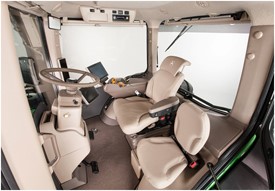 CommandView III cab
CommandView III cab
The Premium CommandView III cab offers unsurpassed visibility, operator comfort, control placement, and ride and sound quality.
Features:
- ComfortCommand™ seat with air suspension and lumbar support, swivel, fore-aft and lateral attenuation, backrest angle adjustment, adjustable left-hand armrest, and 40-degree right-hand seat swivel
- Four-corner cab suspension
- Behind-the-seat storage and left-hand storage compartment
- Folding instructional seat
- Beverage holders sized to accommodate various containers
- Interior left-hand dome light
- Tilt/telescoping steering wheel with position memory
- Adjustable right-hand CommandARM™ armrest controls with integrated CommandCenter™ display
- Monitor mounts on right-hand front post and rear cab post
- Digital cornerpost display with:
- Fuel level gauge, including low fuel warning
- Temperature gauge
- Diesel exhaust fluid (DEF) gauge, including low DEF warning
- Engine rpm
- Transmission commanded gear or speed
- Vehicle system functions, such as iTEC™ system, that are operating
- Swing-out rear window that opens 30 degrees
- Front, rear, and right-hand windshield wiper and washer
- Two-speed and intermittent front and rear wiper
- Front, rear, and right-hand side sunshades
- Right and left outside wide-angle mirrors (electrically adjustable and heated)
- Inside-mounted rearview mirror
- Roof-mounted license plate bracket with light
- Window break
- Pin for tow point
- Passive noise reduction system
- Laminated glass
- Service ADVISOR™ data port
- Power strip with convenience plug adapter
- Two 12-V convenience outlets (cigarette lighter style)
- One 12-V 3-pin outlet with adapter (provides switched and unswitched power)
- One International Organization for Standardization (ISO) 9-pin connector
- Standard radio package, including AM/FM stereo and weatherband with remote controls, auxiliary input jack, four speakers, and an external antenna
Four-corner cab suspension
8RT Series Tractors feature the Premium CommandView III cab with cab suspension in base. Producers will enjoy all the features they have come to expect in the Premium CommandView III cab plus the addition of improved ride quality in the field and on the road with the cab suspension. The cab suspension, combined with the proven AirCushion™ suspension system, will give John Deere operators the most comfortable operating experience available in a two-track tractor.
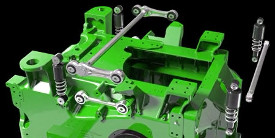 Four-corner cab suspension system
Four-corner cab suspension system
 Cab suspension components
Cab suspension components
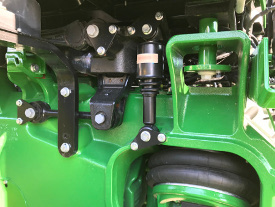 Cab suspension components
Cab suspension components
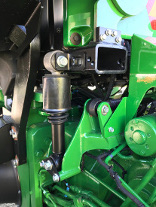 Cab suspension components
Cab suspension components
Steering system
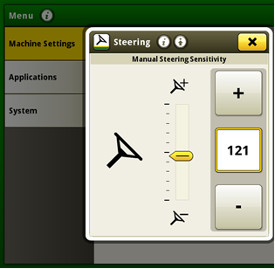 Steering sensitivity adjustment screen
Steering sensitivity adjustment screen
 Steering pump and loop override circuit
Steering pump and loop override circuit
Steering circuit change and steering sensitivity adjustment
8RT Series Tractors include an improved steering pump, changes to the loop-override circuit, and in-cab steering sensitivity adjustment.
The improved steering pump and changes to the loop-override circuit increase steering response and steering authority on 8RT Series Tractors. Operators will notice this change when working in heavy draft, soft field conditions, and obstacle avoidance. The steering pump and loop-override circuit give the 8RT the ability to turn under load like no other two-track tractor in the industry.
8RT steering sensitivity adjusted in the 4600 CommandCenter Display
This feature allows operators to fine tune the steering system based on the application or environment.
Steering sensitivity adjustment does not only help when steering the tractor manually. Operators using guidance systems will also experience improved response with the ability to input tractor tread settings in the 4600 CommandCenter Display. From there, the tractor will control the steering pump to ensure steering is consistent no matter which tread setting the operator is utilizing.
Pull-down front, rear, and right-hand sunshade
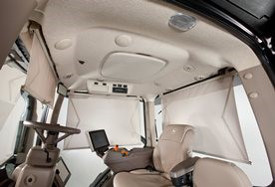 Pull-down sunshades
Pull-down sunshades
These variable-length sunshades provide excellent adjustability to keep direct sun off of the operator. Perforations in sunshade material provide visibility through the sunshade as well. The sunshades are also recessed into the headliner for storage when not in use.
Right- and left-outside mirrors, electrically adjustable
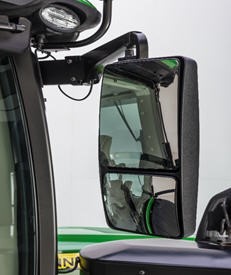 Right-hand mirror shown on 8RT Series Tractor
Right-hand mirror shown on 8RT Series Tractor
Right and left outside wide-angle mirrors are electrically adjustable with simple in-cab adjustments to view variable-width implements, wagons, or carts. The in-cab controls are located directly above the radio.
Leather comfort option
The leather seat option is available on 8RT Series Tractors. The kit includes leather operator seat, leather instructional seat, leather-wrapped steering wheel, rear window decal, and carpet floormat.
NOTE: The leather comfort package is not available with Scraper Special Tractors.
 Leather seats
Leather seats
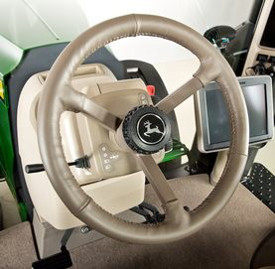 Leather-wrapped steering wheel
Leather-wrapped steering wheel
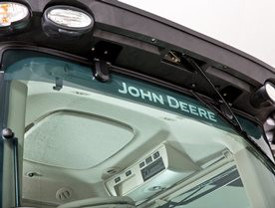 Rear window decal
Rear window decal
CommandARM
 CommandARM controls
CommandARM controls
John Deere 8RT Series Tractors feature the CommandARM with integrated Generation 4 CommandCenter display. The control layout of the CommandARM utilizes a clean and efficient design which groups controls by function and builds upon John Deere’s history of intuitive and ergonomic control placement and operation. The CommandARM control’s design allows for a 40 degree right seat swivel and adjustable positioning matching the operator’s preference.
Controls located on the CommandARM include:
- Engine throttle
- FieldCruise™ system
- Minimum engine speed – e23™ transmission with Efficiency Manager™ feature, Infinitely Variable Transmission (IVT™)
- Eco mode
- Foot pedal lock (if equipped)
- Transmission control
- Hitch/selective control valve (SCV) controls
- Rotary encoder hitch control
- Power take-off (PTO) controls
- iTEC sequence switches
- AutoTrac™ assisted steering system resume switch (if equipped)
- Joystick (if equipped)
- Radio
- Beacon light on/off
- Hazard lights on/off
- Field lights 1/2
- Heating, ventilation, air conditioning (HVAC) system
Seat swivel
 Seat swivel
Seat swivel
The design of the CommandARM controls allows for up to 40 degrees of right-hand seat swivel.
Transmission controls
John Deere 8RT Series Tractors equipped with the e23 transmission with Efficiency Manager feature or AutoPowr™ IVT transmission feature either a left-hand or right-hand reverser.
The transmission control lever is placed on the CommandARM control’s left side closest to the operator for convenient setting and adjustment.
 Left-hand IVT and PowerShift™ transmission reverser
Left-hand IVT and PowerShift™ transmission reverser
 Right-hand IVT and PowerShift transmission reverser
Right-hand IVT and PowerShift transmission reverser
 Throttle
Throttle
 Foot throttle
Foot throttle
ComfortCommand seat
 ComfortCommand seat
ComfortCommand seat
The ComfortCommand seat with air suspension improves ride quality and helps to reduce operator fatigue. The ComfortCommand seat with air suspension is offered with cab suspension. The ActiveSeat™ is available on fixed cab tractors.
Features include:
- Armrests, lumbar support, and backrest angle are easily adjusted to match operator preference
- Shock absorbers dampen the motion effect of the tractor for an improved ride
- Seat height adjustments are conveniently located on the left armrest
- Fore-aft adjustment is easy to reach located on the left front of the seat
- Swivel adjustment, located on the front of the seat, allows the seat to be swiveled 40 degrees to the right or eight degrees to the left of the center position
- Operator presence switch warns if the operator is out of the seat while operating key functions
- Seat belt retractor
- Centered cab seat, providing excellent over-shoulder visibility
- Adjustable shock absorber permitting ride adjustment from soft to firm to match the operator's desired comfort level
- Removable cushions for easy cleaning
Hydraulic and hitch controls
Hydraulic and hitch controls utilize fingertip paddle pots for raise/lower and extend/retract functions. An optional crossgate joystick replaces fingertip paddle pots for control of SCVs and allows for programmable hydraulic functionality according to operator preference. Rear hitch position can also be controlled with the encoder wheel located on the right side of the CommandARM. The encoder wheel allows for finite positioning of the rear 3-point hitch.
Three buttons near the encoder are for hitch set, lock, and return to height. Adjustment for the 3-point hitch is done via the CommandCenter display.
 Fingertip paddle pots
Fingertip paddle pots
 Encoder wheel
Encoder wheel
 Optional crossgate joystick
Optional crossgate joystick
Throttle
The throttle design incorporates buttons which control FieldCruise speed, foot pedal mode (if equipped), and transmission eco settings.
Tractor function controls
Located just to the right of the throttle is the AutoTrac activation button and four sequence controls for iTEC functions.
 AutoTrac resume and iTEC strip
AutoTrac resume and iTEC strip
Controls for radio, lights, rotary beacon (if equipped), hazard flashers, and HVAC system are located to the center-right on the CommandARM, along with PTO for both front (if equipped) and rear.
 Radio, HVAC, hazard flashers, and PTO controls
Radio, HVAC, hazard flashers, and PTO controls
CommandCenter display
 Generation 4 CommandCenter display
Generation 4 CommandCenter display
The Generation 4 CommandCenter displays feature fast adjustment of tractor functions and controls and are integrated into the CommandARM to create a seamless control center. The 4600 CommandCenter features a 26.4-cm (10.4-in.) touchscreen display and is standard equipment on 8RT models.
The following functions can be adjusted using the CommandCenter display:
- Hydraulic settings
- Hitch settings
- Transmission settings
- FieldCruise
- iTEC programming functions
- Radio
- Lights
Cooled exhaust gas recirculation (EGR)
 PowerTech™ PSX 9.0-L engine
PowerTech™ PSX 9.0-L engine

How exhaust gas recirculation (EGR) works
EGR reduces the high temperatures where nitrogen oxide (NOx) compounds are formed in the engine cylinders by replacing excess oxygen with a prescribed amount of cooled exhaust gas.
Exhaust gases contain more carbon dioxide than oxygen. The EGR valve in conjunction with the venturi and engine control unit (ECU) allows a controlled amount of exhaust gas to enter the intake manifold to mix with the incoming fresh air. Replacing excess oxygen with cooled exhaust gas leads to lower combustion temperatures, creating less NOx. In addition, EGR allows for advanced timing, leading to optimal performance of the engine, maximizing fuel economy.
The following diagrams illustrate how air flows through the engine.
For added performance and efficiency, the engine passes the exhaust gases through an EGR cooler before it enters the engine.
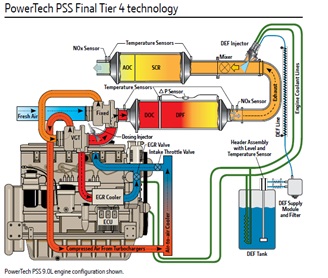 PSS engine diagram
PSS engine diagram

Flow of exhaust during engine operation
Exhaust airflow enters into the EGR cooler from the exhaust manifold near the turbocharger.
Based on engine load, air temperatures, and rpm, the engine control unit (ECU) opens or closes the EGR valve, allowing a measured percentage of exhaust gas to enter the intake manifold.
The gases mix with the rest of the incoming air from the turbocharger and aftercooler before entering the cylinders.
Front power take-off (PTO) options for increased versatility
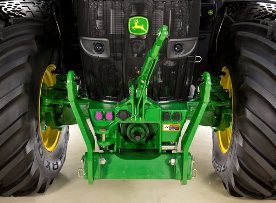 Front PTO
Front PTO
For increased versatility, two 1000-rpm front PTO options are available from the factory for 7R and 8R Series Tractors equipped with the John Deere front hitch.
- Type 2, 1000-rpm (counterclockwise as seen from front), 35-mm (1 3/8-in.), 21-spline front PTO
- Type 3, 1000-rpm (counterclockwise as seen from front), 45-mm (1 3/4-in.), 20-spline front PTO
Front PTO features include:
- The ability to be incorporated with iTEC™ sequences
- Three choices of engagement modulation: auto, low, and high
- Integrated controls
- Cornerpost display indicators
- Bolt-on shaft makes it easy to change shafts if necessary.
- Remote PTO engagement
7R-specific features:
- 130 kW (175 hp)
- Integrated with all transmissions
- PTO disconnect for efficiency
- Requires TLS front axle
8R-specific features:
- 112 kW (150 hp)
- Integrated with the infinitely variable transmission (IVT™)
- Requires Independent-Link Suspension (ILS™) with front brakes
Intelligent Power Management (IPM)
IPM is compatible with 7R and 8R Series Tractors equipped with a front PTO option. The front PTO, rear PTO, or transport speeds can activate IPM on 7R Tractors. However, on 8R Tractors, IPM is only activated by the rear PTO or by transport speeds. For example:
- A front snow blower will not benefit from IPM on an 8R since the front PTO alone will not activate IPM.
- A triple-mounted mower-conditioner will benefit from IPM as high power levels are transmitted via the rear PTO. The front mower-conditioner will have 150 hp available to it on an 8R, which is adequate to operate these mowers in most crop conditions.
- See Intelligent Power Management for more information
PTO disconnect on 7R Series Tractors
Disconnecting the PTO drive to the PTO box when not in use increases tractor efficiency by reducing:
- Power requirements, which saves nearly 70 percent of power required to run the PTO disengaged
- Wear on components of the PTO box; components are not moving when the PTO is disconnected
Refer to the operator’s manual for instructions on how to disconnect the PTO when not in operation.
Front PTO operation
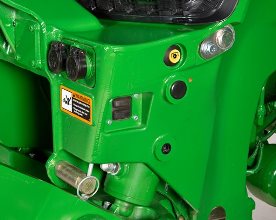 Remote control at front of tractor
Remote control at front of tractor
Front PTO engagement is actuated through an engagement switch similar to the rear PTO located on the CommandARM™ controls.
- PTO clutch is electronically activated with automatic torque modulation.
- PTO modulation is selectable through the CommandCenter™ console and display.
- To activate the PTO remotely, select the remote PTO enable button in Generation 4 CommandCenter display, push down and forward on the FPTO switch in the cab and use the remote control at the front of the tractor.
NOTE: For the 8R Series, if the tractor is equipped with a front PTO, additional IPM power will transfer through the front PTO. However, IPM activation is only sensed through the rear PTO. Adequate load must be sensed on the rear PTO in order for IPM to activate.
Gold Key Program Waterloo operations


The John Deere Waterloo Operations Gold Key Program was designed to recognize and honor those purchasing Waterloo-built tractors. The Gold Key tour provides an opportunity for a customer to follow his or her tractor as it is built on the assembly line. If a Gold Key customer is unable to visit the day the tractor is on the assembly line, the customer may elect an alternative date within 90 days to schedule a tour. This will be recognized as a Gold Key experience where the customer adopts a tractor to follow rather than watch his or her own tractor being built. After 90 days, the visit will be deemed a VIP tour and Gold Key memorabilia will not be provided.
Definition of a Gold Key tour
A Gold Key tour entails an exclusive, behind-the-scenes guided tour of the assembly production lines. The customer, or product owner, may bring up to three additional guests on the tour. Tour participants will wear Gold Key owner identification bump caps and other personal protective equipment while being escorted privately by a tour guide. Every attempt will be made to make sure the customer will see the specific tractor ordered come off the final assembly line; however, in order to satisfy delivery needs, the first priority is to keep the manufacturing lines running at full capacity.
The Gold Key visit date is based on when the customer’s tractor is expected to reach the final line. It is John Deere’s goal that a customer drives his or her tractor off the final line at the end of the tour. It is imperative to notify the John Deere dealer from whom the tractor was purchased in order to initiate a Gold Key tour. The John Deere dealer will be required to register guests on the Gold Key registration website as soon as possible if a Gold Key visit is requested. The owner will be presented with a gold key, a certificate, and other memorabilia at the conclusion of the factory visit. Breakfast and lunch will also be provided the day of the tourisit.
Process of Gold Key tour
The owner will need to notify the John Deere dealer where the Waterloo-built 6000 Series – 9000 Series Tractor was purchased. The Gold Key coordinator will be the sole contact with the dealership representative to make visit arrangements and confirmations for the visit.
Shortly after the Gold Key coordinator confirms the request, all appropriate paperwork and information will be sent to the dealer. The customer will then receive all welcome documents in the mail. The Gold Key coordinator will also make direct contact with the customer to confirm the visit.
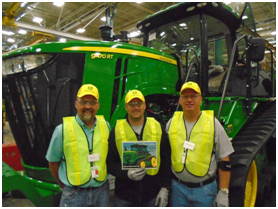 Ahrens Farms
Ahrens Farms

Ahrens Farms of Owatonna, MN participated in the Gold Key Tour at John Deere Waterloo Works in 2015. They purchased a 9470RT Tractor.
While every attempt will be made, and the factory will do everything possible to allow a customer to see his or her tractor being built, production schedules change for many reasons. Should production change at the last minute, the owner may arrive only to find that either the tractor has been pushed back or pulled ahead and already built. While that is certainly not the intention, the possibility remains.
The factory cannot be responsible for:
-
Production delays, work ahead, or production revisions
-
Any option changes at the factory level
-
Overnight accommodations; however, assistance with information is available upon request
-
Travel costs
Gold Key Tour guidelines
- All Gold Key tours must be initiated by the selling John Deere dealer through the Gold Key profile request form.
- The Gold Key coordinator at the Waterloo Tractor Factory will be responsible for updating the customer and dealer of the tractor build status.
- Gold Key treatment will not be recognized if any of the requirements are not met prior to arrival at the factory.
- The Gold Key Program is only available within 90 days of the tractor's build date.
- Every attempt will be made to make sure the customer will see his or her tractor come off the assembly line; however, the factory has first priority for production obligations.
- Gold Key tours are limited to the customer and three other persons, no more than four people total (excluding dealer).
- All guests attending Gold Key tours must be 13 years of age or older. Any teenage children must be accompanied and under constant supervision of a parent and/or guardian.
- No personal cameras or video cameras are allowed on the production floor during the tour. A camera from John Deere will be given to Gold Key guests for the duration of the tour.
- Tour participants must abide by all factory tour safety rules and regulations.
- Gold Key tours will be restricted if maximum tour capacity has been reached due to previously scheduled tours or special events.
Take advantage of the Generation 4 CommandCenter™ display, designed for efficiency
The 4200 and 4600 CommandCenter, also known as the Generation 4 CommandCenter, create the primary user interface for 6R, 7R, 8R/8RT, and 9R/9RT/9RX Tractors; F4365 High-Capacity Nutrient Applicator; 4 Series Self-Propelled Sprayers; and S700 Combines. The Generation 4 CommandCenter provides an excellent, user-savvy, efficient operating experience.
Display options
Generation 4 CommandCenter is available in the following configurations:
- 21.3-cm (8.4-in.) display on the 4200 CommandCenter
- 25.4-cm (10-in.) display on the 4600 CommandCenter
For growers wanting to maximize their viewing real estate, the 25.4-cm (10-in.) touchscreen color display is an excellent choice. With the 25.4-cm (10-in.) display, the title bar and all shortcut keys may be viewed at all times, allowing operators to monitor more information at once.
 John Deere 4200 CommandCenter
John Deere 4200 CommandCenter
A. Next run page
B. Status center
C. Expand shortcut keys
D. Menu
E. Run page
 John Deere 4600 CommandCenter
John Deere 4600 CommandCenter
A. Next and previous run page
B. Status center
C. Shortcut keys
D. Menu
E. Run page
F. Title bar
John Deere Generation 4 CommandCenter Processors
A Generation 4 CommandCenter is made up of a processor and a display. Two processor options are available for the Generation 4 CommandCenter.
 4200 CommandCenter 21.3-cm (8.4-in.) display
4200 CommandCenter 21.3-cm (8.4-in.) display
The 4200 Processor is base equipment and only offered on 6R, 7210R, and 7230R Tractors.
It offers:
- Compatibility with 21.3-cm (8.4-in.) touchscreen display
- One video camera input
- One USB input
- AutoTrac, Data Sync, and Section Control capable (machine-specific activation sold separately)
CommandCenter compatibility
The table below shows the model year of machines equipped with CommandCenter. Upgrade kits are available for 4100 to 4600 for machines that came equipped with a 4100 CommandCenter from the factory. There are no upgrade kits for converting a 4200 to 4600 at this time.
4200 CommandCenter is available starting with model year 2019 6R, 7210R, and 7230R Tractors.
| Vehicles | Model year | 4200 Processor | 4600 Processor |
| John Deere tractors | |||
| 6R Series (AutoQuad™ transmission/CommandQuad™ transmission) Series | 2019 and newer | Standard | Not applicable |
| 6R (IVT transmission/DirectDrive), 7210R, 7230R Series | 2019 and newer | Standard | Option |
| 7250R, 7270R, 7290R, 7310R Series | 2014 and newer | Not available | Standard |
| 8R/8RT Series | Mid-2014 and newer | Not available | Standard |
| 9R/9RT/9RX Series | 2015 and newer | Not available | Standard |
| John Deere nutrient applicators | |||
| F4365 Nutrient Applicator | 2017 and newer | Not available | Standard |
| John Deere self-propelled sprayers | |||
| 4 Series Sprayers | 2018 and newer | Not available | Standard |
| John Deere combines | |||
| S-Series Combines | 2018 and newer | Not available | Standard |
Expect easier set-up, along with increased operator confidence, thanks to a simple, customizable interface. The improved design of the Generation 4 CommandCenter also aids in an optimal operating experience and maximizes uptime.
Some of the easy-to-use benefits of the Generation 4 CommandCenter include:
- Custom-defined views
- Intelligent warnings
- Context-based help
- Ability to import, export, and delete files
Producers can use a variety of implements with the Generation 4 CommandCenter as it is Agricultural Industry Electronics Foundation (AEF) ISOBUS compliant for manual control of IOSBUS implements (UT) as well as automatic section control (TC-SC) and documentation in ISOXML format (TC-Basic).
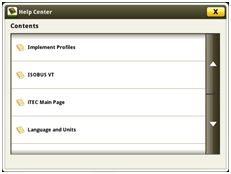 Help center main page
Help center main page
Additionally, application-based help is also available in all locations of the CommandCenter. Simply click on the {i} icon available on the title bar and it will lead directly to more information on the application currently being used.
 Context-based help icon
Context-based help icon
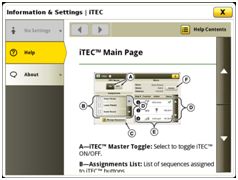 Context-based help on iTEC™ system main page
Context-based help on iTEC™ system main page
Diagnostic text and information is available for better understanding of whether applications are operating as directed.
Machine monitor
 Machine monitor page
Machine monitor page
The machine monitor application provides the operator instantaneous readings about the status or condition of the machine. Values shown in the machine monitor vary by application, but typically include parameters like engine speed, coolant temperature, and ground speed. The machine monitor supports run page modules in the Layout Manager, allowing the operator to populate specific machine parameters directly to a run page.
NOTE: The machine monitor application replaces part of the universal performance monitor in previous machines.
 Work setup shortcut key (far left)
Work setup shortcut key (far left)
 Work setup
Work setup
Video capability
Tractors with a 4200 CommandCenter are equipped with one video input, and the 4600 CommandCenter Display has four video inputs. The operator has the ability to set a variety of triggers, including reverse, PTO, hitch, and selective control valve (SCV) levers to activate the camera. Once triggered, the image will then appear on the CommandCenter display. The camera (video observation system) is available through JD Parts and Ag and Industrial (A and I) Products.
Video looping supported with Gen 4 4600 CommandCenter Display and 4640 Universal Display
This feature enables users to scan or loop through all of the available video feeds for a specified duration. The default scan time is set to 7 seconds per image. The scan time is customizable between 1 and 300 seconds per image before continuing the loop, providing constant visibility to all video feeds.
 4600 CommandCenter 25.4-cm (10-in.) Display
4600 CommandCenter 25.4-cm (10-in.) Display
The 4600 Processor is the premium processor, offered as an option on all 6R*, 7210R, and 7230R Tractors and is standard on 7250R, 7270R, 7290R, 7310R, 8R/8RT, 9R/9RT/9RX Tractors, F4365 Nutrient Applicator, 4 Series Self-Propelled Sprayers, and S700 Combines.
Available features with the premium processor include:
- Compatible with 25.4-cm (10-in.) touchscreen display Four video camera inputs Four USB inputs
- Wireless Data Transfer
- AutoTrac™ guidance capable (machine-specific activation sold separately)
- Machine specific activations including CommandCenter Premium and CommandCenter Automation enable Section Control, Data Sync, RowSense, In-Field Data Sharing, AutoTrac Implement Guidance, AutoTrac Turn Automation, Machine Sync and John Deere Wireless Data Transfer (WDT) (with a JDLink™ Connect subscription)
- Export screenshots and troubleshooting information easily from the display
*Only compatible with Infinitely Variable Transmission (IVT™) and DirectDrive™ transmission
Layout manager
 Layout manager selection page
Layout manager selection page
 Layout manager module build
Layout manager module build
The Generation 4 CommandCenter features a modular-designed layout manager, so operators can easily create the page views that meet their needs. From the factory, machines are equipped with default run pages. An unlimited number of run pages can be added to the Generation 4 CommandCenter based on operator preference or operational needs. Toggling between run pages is as easy as swiping the screen or using the arrow buttons on the top right portion of the title bar.
Users and access
Users and access allow the owner or manager to lock out certain functions to prevent operators from accessing or changing settings. Lock-out functions are managed with a defined four-digit code.
Lock-out features are available for:
Factory data reset
Hitch
Hydraulic
Transmission
Power take-off (PTO)
FieldCruise™ system
Display
Machine monitor
On-screen help and diagnostic text
There are a number of different ways to get meaningful on-screen help when navigating the Generation 4 CommandCenter. Operators can find the help icon on the shortcut bar on the bottom of every page. This icon gives detailed information on everything from tractor operation to application information. Simply select the help icon and navigate to the information section that is needed.
Work monitor
 Work monitor page
Work monitor page
The work monitor application displays performance information about the task being performed by the machine. The operator is shown averages, totals, and productivity of the machine, such as area worked, average working speed, and fuel usage. The values of the work monitor can be reset by the operator at any time. Specific values of the work monitor can be configured by the operator to be shown on a run page.
NOTE: The work monitor application replaces part of the Universal Performance Monitor in previous machines.
Work setup application
Work setup places the settings needed to properly setup AutoTrac, Documentation, and Section Control in a single location.
Settings include:
- Client, farm, and field
- Crop type
- Machine and implement dimensions
- Variety/hybrid and planting/ seeding rates
- Variable rate prescriptions
- Product and application rates
- Application rates through the implement screens
Work setup can be quickly accessed from a shortcut key or the display menu, allowing operators and managers to quickly review display and machine settings to ensure a job is completed properly.

NOTE: 6R Tractors equipped with a 4600 CommandCenter Display have two video inputs.
Dual-display mode
 Dual display
Dual display
Generation 4 CommandCenter display and GreenStar displays comparison and compatibility
The Generation 4 CommandCenter works in dual-display mode with GreenStar 3 2630 Display, GreenStar 2 1800 Display, and GreenStar 2 2600 Display.
Generation 4 CommandCenter may be configured to run with the following John Deere displays connected at the cornerpost of a John Deere tractor:
- GreenStar 2 1800 Display
- GreenStar 2 2600 Display
- GreenStar 3 2630 Display
- 4640 Universal Display
- 4240 Universal Display
Vehicle applications will always be located on the Gen 4 CommandCenter.
View on-screen help to properly set up the display when in dual-display mode by clicking on the icon (pictured below).
Flags
 Create flags to mark items in the field
Create flags to mark items in the field
Mark areas of the field that need special attention or items that need to be addressed such as rocks, tile lines, or weed pressure. Flags previously recorded on the Gen 4 or GreenStar™ 3 2630 Display can be transferred between displays to ensure each operator is aware of upcoming field obstacles.
Document field boundaries
Manually drive field boundaries with the Generation 4 CommandCenter or import existing boundary information from the GreenStar 3 2630 Display or John Deere Operations Center. Gen 4 documentation data can be used to create boundaries from coverage within the John Deere Operations Center.
The display uses a streamlined boundary creation process that generates exterior and interior field boundaries from coverage, simplifying the process and reducing steps. Operators can delete interior boundaries without impacting the exterior boundary or headlands. In addition, operators can choose to turn boundaries off for section control while using them for field locator and documentation.
Headland boundaries can also quickly be generated by simply entering a distance or the number of passes from an exterior boundary.
 Boundary creation from coverage
Boundary creation from coverage
 Headland creation
Headland creation
Boundaries can be imported from the following sources:
- John Deere Operations Center
- Directly from a GreenStar 3 2630 Display or another Gen 4 Display
- APEX™ software or another farm management information system (FMIS) system that exports in GreenStar 3 2630 Display format
Automatic base station switching
 Setup base stations in Fields & Boundaries applications
Setup base stations in Fields & Boundaries applications
Customers using John Deere RTK Radio 450 or 900 can link a base station to a desired client/farm/field. This allows automatic switching to the associated base station when changing fields. The ability to import base station assignments into Operations Center and send back to machines will be available at a later date.
Features
Lighting packages provide 360 degrees of coverage for maximum productivity
 Premium lights
Premium lights

The 7R, 8R, and 8RT Series Tractors feature two lighting package options:
- Standard
- Premium
The cab lighting pattern provides 330 degrees of coverage while the hood lighting provides the remaining 30 degrees for completely programmable 360-degree, stadium-style lighting. This ensures there are no dead zones or lighting adjustments needed. The lighting configurations are available to match various applications and ensure maximum around-the-clock productivity.
Bulb housings are large, allowing for optimum total lumens and available light. The standard lighting packages use 65-W halogen bulbs, whereas the premium lighting package uses light-emitting diode (LED) lights. In the premium lighting package, these tractors take advantage of the high-performing and efficient LED technology.
The low- and high-beam driving/work lights are adjustable. Please refer to the electrical section in the operator’s manual for complete details on adjusting lights.
 7R/8R/8RT lighting
7R/8R/8RT lighting

Yellow circles
- All lighting packages: 65-W halogen: road low beam
Red circles
- Standard: 65-W halogen
- Premium: LED
Blue circles
- Standard: 65-W halogen; field and road high beams
- Premium: LED
Orange circles
- Standard: blank
- Premium: LED
|
Standard lighting
 Standard lighting (8R)
Standard lighting (8R)
 Standard lighting (7R)
Standard lighting (7R)
Six front grill-mounted lights:
- Two 65-W low-beam driving/work lights (mid grill screen)
- Two 65-W high-beam driving/work lights (top of grill screen, hood mounted)
- Two front corner-facing halogen work lights (top of grill screen, hood mounted)
10 cab roof-mounted lights:
- Two rear-facing 65-W floodlights
- Four side-facing 65-W floodlights
- Four corner-facing amber lights
Other lights:
- Two rear fender-mounted floodlights
- Two rear turn signal and brake/tail lights (fender mounted)
- Two folding-extremity lights
Plus these lights:
- Two adjustable front roof 65-W halogen floodlights
- Two front belt-line floodlights
- Rotary beacon light
Premium lighting
Eight front grill-mounted lights:
- Two 65-W low-beam halogen driving/work lights (mid grill screen)
- Two LED high-beam driving/work lights (top of grill screen, hood mounted)
- Two front corner-facing LED work lights (top of grill screen, hood mounted)
- Two front-facing LED working lights (top of grill screen, hood mounted, inner position on the sides)
12 cab roof-mounted lights:
- Four side-facing LED lights
- Four corner-facing amber lights
- Two rear-facing LED lights
- Two adjustable front roof LED lights
Other lights:
- Two rear fender-mounted LED lights
- Two rear turn signal and brake lights (fender mounted)
- Two folding-extremity lights
- Two front belt-line LED floodlights
- Rotary beacon light
The premium lighting package replaces all previous halogen and HID lights with LED lights. The only lights that are not LED are the low-beam driving lights, they remain halogen. This allows each LED light to work at a lower temperature and no one light works harder than any other. The uniformity in LED coverage allows only one type of light output surrounding the tractor.
The lighting pattern in the premium package provides industry-leading performance in nighttime visibility. LED bulbs provide maximum brightness and a true color output for excellent field definition that is easy on the operator's eyes.
The LED lights provide 40 percent greater coverage width and 10 percent more light coverage in the rear. LED lighting packages use 45 percent less amps than standard halogen lights and have an increased life expectancy over HID lights which leads to lower costs of ownership over the life of the tractor.
NOTE: Lighting packages may vary depending on region.
Selecting a lighting mode/programmable lighting
 Lighting mode selector
Lighting mode selector

Operators can quickly select a lighting mode on the steering console:
- Lights, off position
- Road lights
- Field lights
 The CommandCenter™ display
The CommandCenter™ display
The CommandCenter display allows operators to customize light settings. Operators can select only the lights they need or want for a given application and store these settings. The operator-programmed configurations can then be turned on or off with the push of a button on the CommandARM™ controls.
- Programmable field lights 1
- Programmable field lights 2
- Beacon light
- Emergency flashers
NOTE: Road/loader lights are also referred to as high-mounted driving lights for use in front hitch applications that obscure the headlights. See the Attachments section.
The battery power saver feature is also standard. When the engine is off and the outside lights have been left on, this feature is designed to avoid battery run down.
After the lights have been left on for 30 minutes and the key is in the off position, the lights cycle or blink on and off five times as an alert. The lights continue to illuminate for one more minute and then automatically shut off to protect the battery.
Programmable exit lighting
Another feature is programmable exit lighting. Exit lighting allows the lights outside the cab to stay on for up to 300 seconds. They can be programmed in increments from 0 to 300 seconds.
Refer to the operator’s manual for complete instructions on programming field, driving, and exit lighting.
Field-installed options
Field-installed options are also available. To find this information, use the Build Your own Configurator application for US/Canada or Build & Price in John Deere Sales Centre for Australia/NZ.
| Option code | Description |
| 7201 | Standard lighting |
| 7206 | Premium lighting |
ActiveCommand steering (ACS™) provides a robust and full-encompassing steering system
ACS overview
 8R in transport
8R in transport

With ACS, John Deere has designed one of the most robust and full-encompassing steering system in the industry. Whether in the field or on the road, ACS reduces steering effort, which can result in reduced operator fatigue and can improve operator comfort.
There are four key features of the ACS system:
Dynamic road wheel offset:
- A gyroscope senses tractor yaw and can automatically make small steering adjustments to provide unprecedented line-holding abilities. Drive down a bumpy road and experience how ACS makes it easier to keep the tractor straight, even over rough terrain. ACS delivers the ultimate in comfort.
- ACS works to prevent over-steering when a sudden obstacle causes the operator to make a quick steering reaction.
Variable ratio steering:
- Approximately 3.5 turns lock-to-lock at in-field speeds for quick headland turns.
- Approximately 5 turns lock-to-lock at transport speeds.
Elimination of steering slop and hand wheel drift:
- Steering wheel drift and slop are eliminated with the ACS electronic control system.
Variable effort steering:
- Steering wheel resistance automatically changes with ground speed to deliver light steering effort at slower speeds for less effort during headland turns, and higher steering wheel torque at transport speeds for better comfort.
A fail operational system
The ACS system is fail operational, which means steering is still functional in the event of any single-point failure. John Deere has gone to great lengths to help ensure the operator has the ability to steer the tractor if something goes wrong in the steering system.
For example, if the primary controller fails, a second controller takes over. If power from the alternator fails, the battery resumes control. If the engine quits running and is unable to supply hydraulic oil to the system, an electric-driven backup pump is used to supply the oil. There is a backup for ACS components.
 ACS components
ACS components

The ACS system consists of several key components:
- Gyroscope: this is used to measure the yaw rate (turn rate) of the tractor during transport speeds.
- Road-wheel angle sensors: these sensors simply measure the steer angle of the tractor.
- Power supply module: this module distributes the power of the battery and alternator throughout the ACS system.
- Hand-wheel angle sensors and tactile feedback unit: this includes the steering wheel position sensors and a brake which can increase or decrease resistance dependent on speed. Lighter feedback is desired during normal field use, and slightly heavier feedback is desired during transport and while the tractor is cornering at high speeds.
- Controllers: two controllers are located in the back of the tractor and are the brains of the system.
- Control valves: also known as steering valves, control valves are used to steer the tractor.
- Electric-drive backup pump: this pump supplies oil to the steering system, brakes, and park (for towing) brake if there is no longer a sufficient oil supply to the steering and brakes.
Value of ACS
- Improves line holding when driving at transport speeds
- Fewer turns lock-to-lock: 3.5 turns lock-to-lock in the field for quicker headland turns and 5 turns lock-to-lock at transport speeds
- Eliminates hand wheel backlash and drift
- Reduces steering effort results in reduced operator fatigue
- Smaller hand-wheel diameter for improved operator comfort and visibility
- Maintains operator feel and touch-points of traditional steering column system
- Fully integrates with AutoTrac™ guidance assisted steering stems
- Compatible with suspended and non-suspended front axles
- Compatible with wide and narrow section width tires
Independent-Link Suspension (ILS™) utilizes industry-leading technology
 8R Series Tractor equipped with ILS
8R Series Tractor equipped with ILS
 Close-up view of ILS design
Close-up view of ILS design
The John Deere ILS utilizes industry-leading technology to supply unsurpassed gains to end-user productivity. This innovative design incorporates proven suspension design with mechanical front-wheel drive (MFWD) axle components that use state-of-the-art technology specifically for heavy equipment usage.
The ILS front axle is available on all 8R Series Tractor models.
42-km/h (26-mph) and 50-km/h (31-mph) front axles
Feature |
ILS |
Hydraulic differential lock |
Yes |
Limited slip |
No |
Suspension |
Yes |
Brakes |
Yes (optional on 42 km/h [26 mph]) |
Tire ratio/steps allowed |
5 or 6 |
Duals |
Yes |
Tread spacing singles* |
1574 mm - 2184 mm |
Tread spacing singles |
1524 mm - 2235 mm |
Singles with duals |
1524 mm - 2235 mm |
Duals |
2946 mm - 3658 mm |
Top speed |
42 km/h (26 mph) or 50 km/h (31mph) depending on model |
Front power take-off (PTO) |
Optional |
* Based on wheel equipment shipped to some geographic regions.
The ILS system gets more power to the ground because the front tires maintain ground contact pressure. This improves field and transport ride plus increases ballasting flexibility and drastically decreases the tendency to power hop.
 ILS cutaway
ILS cutaway
The ILS axle maintains minimum oil levels in the front differentials to assist in providing overall tractor operating efficiency.
John Deere ILS has three systems:
- A mechanical system
- A hydraulic system
- An electrical system
Mechanical system
The mechanical system is further broken down into the mechanical drive system and mechanical suspension system.
The mechanical drive system includes:
- A three-position switch is included on a MFWD clutch.
- The MFWD clutch has six clutch discs and separator plates that can transfer as much as 40 percent of the tractor power through to the front ILS axle.
- The front differential transfers power from the engine to the individual right and left driveshaft through a ring and pinion.
- A hydraulically engaged front differential lock containing eight clutch discs and eight separator plates works in conjunction with the rear differential lock to assist the tractor in tough, wet conditions with increased power transfer to all wheels.
- A right and left constant-velocity telescoping driveline provides smooth power transfer to the outboard hubs.
- On 8245R, 8270R, 8295R, and 8320R Tractors, the ILS driveshaft speed is 6:1. On 8345R, 8370R, and 8400R Tractors, the ILS driveshaft ratio is 8:1. By using an 8:1 ratio on higher horsepower tractors, power can get to the wheels while minimizing the torque the U-joint experiences.
The mechanical suspension system consists of large cast, upper- and lower-control arms with cast steering knuckles for durability and reliability.
- There is a high steering capacity, even with dual wheels – 25 percent increase over model year 2013
- High torque in all steering positions provides maximum transfer of power to the wheels under all conditions
- Fully independent suspension maintains optimum ground contact at all times
Hydraulic system
The hydraulic system consists of suspension cylinders, a control valve manifold, a front differential lock, and hydraulic accumulators.
- There is a high steering capacity through large steering cylinders.
- Responsive link arms maintain contact with the ground surface, giving maximum tractive performance under any condition.
- Accumulators dampen energy from bumps to produce a smooth ride for maximum operator comfort.
Electrical system
The electrical system contains position sensors, solenoids for the control valves, and a master controller for complete automatic control of the ILS system.
How does it work?
The mechanical, hydraulic, and electrical systems work together to maintain a level and vertically-centered position of the front differential case in relation to the outboard hubs and planetaries, independent of tractor weight or dynamic loading. The system's ability to maintain a vertically centered position provides full suspension travel of 25.4 cm (10 in.). This translates to consistent soil contact for improved power to the ground as well as dampens the energy from bumps that cause a rough ride.
The tractor utilizes electronic and computer controls that monitor tractor functions and axle position. Based on those inputs, the electrical system automatically triggers hydraulic functions to raise, lower, or remain static.
The John Deere ILS uses a short/long A-arm design, which means the upper control arms are shorter than the lower control arms. During wheel movement, the upper control arm moves in a smaller arc than the lower control arm, and the difference in the two arcs creates a change in camber. The change in camber helps keep the inside and outside of the front tires perpendicular to the drive surface, a very important feature when optional front dual wheels are installed. This design provides anti-dive characteristics to naturally reduce the adverse effects of braking and acceleration.
The John Deere ILS front axle has been specifically designed to accommodate additional options, such as front 3-point hitches and front duals. To properly handle these options, large steering cylinders and knuckles provide up to twice the steering capacity of the standard MFWD beam axles so steering performance is maintained. A simple steering stop arrangement offers infinite adjustability for fine-tuning in any row spacing.
Braking system
With higher speeds and expected heavy towed implements and carts, front brakes are optional on 42-km/h (26-mph) ILS-equipped tractors and part of base equipment on 50-km/h (31-mph) ILS-equipped tractors. The braking system is applied proportionally between the front and rear axle brakes to effectively stop the tractor. There are no operator adjustments or requirements to operate the additional braking system.
Tire compatibility
For travel speeds of 50 km/h (31 mph), B-speed-rated tires that provide high-speed capabilities are required.
With the ability to have a six-step drop from rear to front tire, the 8R equipped with an ILS axle is able to have group 49 rear tires with group 43 fronts. This allows for the benefits of group 49 tires while maintain the turning radius allowed by group 43 front tires.
NOTE: The use of group 44 tires for front duals does not allow for some row crop spacings.
Front duals
 8R Series Tractor with front duals
8R Series Tractor with front duals
 Narrow-diameter extension and hub attachment
Narrow-diameter extension and hub attachment
Front dual tires provide:
- Ultimate flotation and compaction management
- Increased load-carrying capacity
- Easy installation or removal; no need to remove the inner tire
- Bolt-on components versus studded flanges for superior flexibility for dual/no dual applications.
- Narrow hub extensions to ensure superior crop clearance for row crop applications
- A serviceability port has been added to eliminate the need to remove the front dual and hub in order to change the hub oil at the required service interval
Hitch application
In hitch applications, it is important to maintain at least 50 percent of the ballasted front-axle weight (with implement raised) for steering control. Referring to the example below, the maximum ballasted weight of the front axle is 7756 kg (17,100 lb). If the tractor has a hitch-mounted implement, when the tractor is weighed with the hitch and implement fully raised, the front weight must be at least 3878 kg (8550 lb). The front axle capacity is directly proportional to the weight that can be carried on the hitch.
The MFWD axle has a front weight carrying capacity equal to the front tire carrying capacity. For example, in row-crop applications using the popular 480/70R34 (155 load index) front tires, the highest load rating is 3878 kg (8550 lb) per tire with a total of 7756 kg (17,100 lb) at maximum tire pressure. This means (depending on tire pressure and speed) there is as much as 3878 kg (8550 lb) available for support of rear implements in transport.
Maximum load carrying capacity of the axle is determined by the load carrying capacity of the tires and whether the tractor is equipped with singles or duals.
Additional ILS features:
There is no on/off switch for ILS operation since the John Deere advanced electronic management system knows when to disengage ILS automatically. The electronic controller will activate a restricted mode of operation, when any of the following conditions are met:
- Both brake pedals are pushed
- The 3-point hitch raise/lower switch is activated
- The tractor is placed in park
- Wheel speed is less than 0.5 km/h (0.3 mph)
- Tractor is correcting for an out-of-level condition
Based on the inputs received (speed, suspension displacement, braking and operator input to hitch and/or remote cylinders), the tractor determines when the system should be active or inactive, making operation simple and efficient.
MFWD CommandARM™ controls for ILS
Shortcut keys on the CommandARM enable the operator to engage or disengage MFWD on the go, even under full load, without stopping or clutching. The switch can be placed in one of the following positions:
1. AUTO
2. On
3. Off (brake assist)
Mode 1 - AUTO
 AUTO light
AUTO light
When this light-emitting diode (LED) light is lit, MFWD is on but automatically disengages when either of the following conditions are met:
- Either brake pedal is depressed and held to allow tighter turns
- Transporting at speeds above approximately 23.0 km/h (13.8 mph) to reduce tire wear; automatically engages when speed drops below 19.0 km/h (11.4 mph)
- When the front wheel turn angle meets an operator-defined point
As with the brake-assist position, when both brakes are depressed, the MFWD automatically engages (if not already on) to provide four-wheel braking.
 Automatic MFWD angle adjustment
Automatic MFWD angle adjustment
Mode 2 - MFWD on
 MFWD light
MFWD light
When this LED light is lit, MFWD engages continuously.
Mode 3 MFWD off (brake assist)
When no LED lights are lit, the MFWD is off. This is also referred to as the brake-assist position. Even though the MFWD is disengaged, when both brakes are pressed at speeds above 5 km/h (3 mph), the MFWD engages to assist braking the tractor.
Differential lock
 CommandARM™ controls with automatic differential lock engaged
CommandARM™ controls with automatic differential lock engaged
 CommandARM controls with manual differential lock engaged
CommandARM controls with manual differential lock engaged
The differential lock is another feature of the ILS axle. When the rear differential lock is engaged or disengaged, the front differential lock is also engaged or disengaged. This also includes a driveline shield.
If one wheel begins to slip, the differential lock can be engaged on the go and the axles are hydraulically locked together for maximum traction. There are two ways to engage the differential lock feature.
- Manual differential lock - differential lock can be engaged manually using a switch on the floor or by manually depressing a button on the CommandARM console. When brakes are depressed, the differential lock will disengage
- Automatic differential lock - when in auto mode, differential lock is engaged when the tractor is driving forward. Differential lock will disengage when front wheel turn angle meets disengage wheel angle setting defined by the operator via the CommandCenter or when either brake pedal is depressed. Differential lock will automatically engage when brakes are released or front wheels are turned straight.
 Automatic differential lock angle adjustment
Automatic differential lock angle adjustment
Additional equipment for use with ILS axle
- 3M front axle spacing kit:
Front axle static weight for the ILS axle shall not exceed 6759 kg (14,900 lb) using the 3M kit - H480 Front Loader
Refer to the material handling section for additional information.
Hydraulic pump options to meet varying flow requirements
All 8R and 8RT Series Tractors come standard with an 85-cc displacement integrated hydraulic pump. This pump provides 227.1 L/min (60 gpm) of hydraulic flow.
A dual-pump option, featuring 85-cc and 35-cc displacement hydraulic pumps, is available for all 8R wheel models. The dual-pump system provides a hydraulic flow of 321 L/min (85 gpm), ideal for running at lower engine speeds.
SCV flow (approximate) |
||
Engine rpm |
Pump flow (85-cm3 pump) L/min (gpm) |
High pump flow (85-cm3 pump + 35-cm3 optional pump) L/min (gpm) |
800 |
86 (23) |
122 (32) |
1500 |
162 (43) |
229 (61) |
1700 |
184 (49) |
260 (69) |
1900 |
206 (54) |
290 (77) |
2100 |
227 (60) |
321 (85) |
Operating the tractor at reduced engine rpm contributes to a quieter cab, reduced fuel usage, and maintains the vacuum while turning and raising the planter on end rows. At 1500 erpm with a 321 L/min (85 gpm) system there will be an available flow of 229 L/min (61 gpm). This is an improvement over an available 162 L/min (43-gpm) flow when operating with a 227 L/min (60 gpm) system at 1500 erpm.
The maximum flow through one selective control valve (SCV) with a standard coupler is 132 L/min (35 gpm). A 19.1-mm (3/4-in.) high-flow coupler allows for a maximum flow rate out of one SCV of 153 L/min (40.5 gpm).
The hydraulic system is a closed-center, power-on-demand system using a load-sensing pressure-flow compensated axial piston pump with full-flow charge and flow prioritization for steering and brakes.
The pump outlet pressure available on demand can range from 3000 kPa (435 psi) for track models and 4000 kPa (580 psi) for wheel models at low standby to 20,400 kPa (2958 psi) at high standby.
Hydraulic pump options:
- 85-cc displacement, 227-L/min (60-gpm) hydraulic pump
- NOTE: Standard on all 8R models.
- 85-cc and 35-cc dual pump option, 321-L/min (85-gpm)
- NOTE: Compatible with 2014 Final Tier 4 (FT4) and newer 8R Wheel Tractors only.
Standard CommandView™ III cab offers unsurpassed amenities
 CommandView III cab
CommandView III cab
The Standard CommandView III cab offers unsurpassed visibility, operator comfort, control placement, and ride and sound quality.
Features:
- ComfortCommand™ seat with air suspension, lumbar support, swivel, fore-aft and lateral attenuation, backrest angle adjustment, adjustable left-hand armrest, and 40-degree right-hand seat swivel
- Operator presence system that warns if the operator is out of the seat while operating key functions
- Folding instructional seat
- CommandARM™ console with integrated controls
- 4100 or 4600 Generation 4 CommandCenter™ display
- Behind-the-seat storage
- Left-hand storage compartment
- Passive noise reduction system
- Service ADVISOR™ data port
- Tilt/telescoping steering wheel with position memory
- Swing-out rear window that opens 30 degrees
- Right- and left-outside mirrors (manually adjustable mirror head)
- Monitor mounts on right-hand front post and rear cab post
- Standard radio package, including AM/FM stereo and weatherband with remote controls, auxiliary input jack, four speakers, and an external antenna
- Laminated glass
- Air conditioner and heater with automatic temperature controls (ATC)
- Two 12-V convenience outlet (cigarette lighter style)
- One 12-V three-pin outlet with adapter (provides switched and unswitched power)
- One International Organization for Standardization (ISO) nine-pin connector
- Power strip with convenience plug adapter
- Hitch control lever lock and selective control lever lock
- Two-speed and intermittent front and rear wiper with washer
- Front pull-down sunshade
- Digital cornerpost display with:
- Fuel level gauge, including low fuel warning
- Temperature gauge
- Diesel exhaust fluid (DEF) gauge, including low DEF warning
- Engine rpm
- Transmission commanded gear or speed
- Vehicle system functions, such as iTEC™ system, that are operating
- Inside-mounted rearview mirror
- Beverage holders sized to accommodate various containers
- Interior left-hand dome light
ComfortCommand seat
 ComfortCommand seat
ComfortCommand seat
ComfortCommand seat improves ride quality and helps to reduce operator fatigue.
Features include:
- Armrests, lumbar support, and backrest angle are easily adjusted to match operator preference.
- Shock absorbers dampen the motion effect of the tractor for an improved ride.
- Seat height adjustments are conveniently located on the left armrest.
- Fore-aft adjustment is easy to reach located on the left front of the seat.
- Swivel adjustment, located on the front of the seat, allows the seat to be swiveled 40 degrees to the right or eight degrees to the left of the center position.
- Operator presence switch warns if the operator is out of the seat while operating key functions.
- Seat belt retractor.
- Centered cab seat provides excellent over-shoulder visibility.
- Adjustable shock absorber permits ride adjustment from soft to firm to match the operator's desired comfort level.
- Removable cushions allow for easy cleaning.
 Fingertip paddle pots
Fingertip paddle pots
 Encoder wheel
Encoder wheel
CommandARM
 CommandARM controls
CommandARM controls
John Deere 7R and 8R Series Tractors feature the CommandARM with integrated Generation 4 CommandCenter display. The control layout of the CommandARM utilizes a clean and efficient design which groups controls by function and builds upon John Deere’s history of intuitive and ergonomic control placement and operation. The design of the CommandARM allows for a 40 degree right seat swivel and adjustable positioning matching the operator’s preference.
Controls located on the CommandARM include:
- Engine throttle
- FieldCruise™ system
- Minimum engine speed – CommandQuad™ transmission, 16-speed PowerShift™ transmission (PST), e23™ transmission
- Eco mode – Infinitely Variable Transmission (IVT™)
- Foot pedal lock (if equipped)
- Transmission control
- Hitch/selective control valve (SCV) controls
- Rotary encoder hitch control
- Power take-off (PTO) controls
- Mechanical front-wheel drive (MFWD) on/automatic
- Differential lock on/automatic
- iTEC sequence switches
- AutoTrac™ assisted steering system resume switch (if equipped)
- Joystick (if equipped)
- Radio
- Beacon light on/off
- Hazard lights on/off
- Field lights 1/2
- Heating, ventilation, air conditioning (HVAC) system
Transmission controls
John Deere 7R Series Tractors with CommandQuad transmissions feature a left-hand reverser. 8R Series Tractors equipped with 16-speed PST are equipped with right-hand reverser. 7R Series Tractors equipped with e23 PST offer a left- or right-hand reverser. 7R or 8R Series Tractors equipped with AutoPowr™/IVT transmissions are offered with either a left-hand or a right-hand reverser.
The transmission control lever is placed on the left side of the CommandARM closest to the operator for convenient setting and adjustment.
 Left-hand CommandQuad/e23 reverser
Left-hand CommandQuad/e23 reverser
 Right-hand IVT and PST reverser
Right-hand IVT and PST reverser
 16-speed PST right-hand reverser
16-speed PST right-hand reverser
Hydraulic and hitch controls
Hydraulic and hitch controls utilize fingertip paddle pots for raise/lower and extend/retract functions. An optional crossgate joystick replaces fingertip paddle pots for control of SCVs and allows for programmable hydraulic functionality according to operator preference. Rear hitch position can also be controlled with the encoder wheel located on the right side of the CommandARM. The encoder wheel allows for finite positioning of the rear 3-point hitch.
Three buttons near the encoder are for hitch set, lock, and return to height. Adjustment knobs for the 3-point hitch are located under the cover for the CommandARM control's storage compartment and allow for adjustment of the rate of drop, hitch height limit, and depth control.
 Hitch controls
Hitch controls
 Optional crossgate joystick
Optional crossgate joystick
Throttle
The throttle design incorporates buttons which control FieldCruise speed, foot pedal mode (if equipped), and transmission eco settings.
 Throttle
Throttle
 Foot throttle
Foot throttle
Tractor function controls
Located just to the right of the throttle is the AutoTrac activation button and four sequence controls for iTEC functions. Behind the iTEC sequence controls, there are buttons which control the activation and deactivation of MFWD and differential lock.
 AutoTrac resume and iTEC strip
AutoTrac resume and iTEC strip
Controls for radio, lights, rotary beacon (if equipped), hazard flashers, and HVAC system are located to the center-right on the CommandARM, along with PTO for both front (if equipped) and rear PTO.
 Radio, HVAC, hazard flashers, and PTO controls
Radio, HVAC, hazard flashers, and PTO controls
Seat swivel
The design of the CommandARM allows for up to 40 degrees of right-hand seat swivel.
 Seat swivel
Seat swivel
CommandCenter
 Generation 4 CommandCenter
Generation 4 CommandCenter
The Generation 4 CommandCenter features fast adjustment of tractor functions and controls and are integrated into the CommandARM to create a seamless control center. The 4100 CommandCenter features a 178-mm (7-in.) touchscreen display and is standard equipment on 7210R and 7230R models, while the 4600 CommandCenter features a 154-mm (10-in.) touchscreen and is standard equipment on 7250R – 7310R models, as well as all 8R and 8RT models.
The following functions can be adjusted using the CommandCenter display:
- Hydraulic settings
- Hitch settings
- Transmission settings
- FieldCruise
- iTEC programming functions
- Radio
- Lights
Tire options for 8R Series Tractors


John Deere 8R Series Tractors are utilized in numerous applications that place different demands on tires. As such, multiple tire offerings are available for 8R Series Tractors to accommodate a wide range of grower needs. Tire options provide variability in terms of ground clearance, tread width, and floatation to match different operating conditions.
John Deere sources 8R Series Tractor tires from the following major brands:
- Mitas® tires
- Firestone® tires
- Goodyear® tires
- Michelin® tires
- Trelleborg® tires
Tire matching (rears and fronts)
 8R Series Tractor
8R Series Tractor

Front and rear tires for 8R Series Tractors are sized and combined under different group sizes based on tire rolling circumference. All front tire options for 8R Series Tractors are classified as group 42, 43, or 44, while all rear tires are classified as group 47, 48, or 49. The approximate overall diameters for each group are shown in the following table.
| Group | Overall diameter |
| 42 | 1498 mm (59 in.) |
| 43 | 1600 mm (63 in.) |
| 44 | 1676 mm (66 in.) |
| 47 | 1955 mm (77 in.) |
| 48 | 2057 mm (81 in.) |
| 49 | 2172 mm (85.5 in.) |
For tractors with mechanical front-wheel drive (MFWD) or Independent-Link Suspension (ILS™) front axles, there typically needs to be five steps (or group size difference) between the front and rear tires to maintain proper tire overspeed between axles. This means the group 42 front tire needs to be matched with group 47 rear tire, and group 43 front tire needs to be matched with group 48 rear tire.
On 1500 MFWD axles, four-step combinations between front and rear tires are also acceptable (determined at the time of ordering the tractor). This means group 44 front tire can be matched with group 48 rear tire, or group 43 front tire can be matched with group 47 rear tire. Six step combinations are possible on tractors equipped with ILS, allowing group 43 front tires to be paired with group 49 rear tires in order to maintain narrower tread functionality with row crop width tire options.
Additionally, tires have a load index rating designed to report the load carrying capability of the tire.
Group 49 rear tires


John Deere 8R Series Tractors are now approved for group 49 rear tires. Group 49 tires have a larger diameter and longer footprint, which results in greater traction in most field conditions compared to smaller group size tires of the same section width and basic design. Group 49 tires also provide a larger air volume than comparable smaller group sizes, which can help control power hop in some conditions.
NOTE:
- Front tread spacing for group 49 tires (group 44 fronts) has to be 1930 mm (76 in.) or wider based on tire size. For 762-mm (30-in.) tread spacings, tractors equipped with ILS may be equipped with group 49 rear tires and group 43 front tires.
- 710/75R42 (group 49) tires are available in singles only (see Configurator for complete offering)
- 480/95R50 (group 49) tires are available in duals only (see Configurator for complete offering)
- Operators will experience a decrease in turning radius with group 49 tires due to the larger-diameter group 44 front tires.
Row width guidelines
Multiple tire options are available for 8R Series Tractors to accommodate multiple applications or row widths. Refer to the minimum recommended row widths for tire options based on the row-width requirements in the following table.
NOTE: Not all tires listed in the chart are available on all John Deere tractors. See your local John Deere dealer for assistance in choosing the proper tires for specific tractor models.
Rear tires |
Minimum recommended row width |
|||||||
508 mm |
559 mm |
762 mm |
813 mm |
1016+ mm |
||||
Rear tire section width |
||||||||
RCI Group |
Approximate outside diameter |
320 mm |
380 mm |
480 mm* |
520 mm* |
620 mm |
710 mm (28.0 in.) |
800 mm (31.5 in.) |
49 |
2175 mm |
|
|
480/95R50 |
|
|
710/75R42 |
|
48 |
2057 mm |
320/105R54 |
380/90R54 |
480/80R50 |
520/85R46 |
620/70R46 650/85R38 |
710/70R42 |
800/70R38 |
47 |
1956 mm |
320/90R54 |
380/90R50 |
18.4R46 480/80R46 |
20.8R42 520/85R42 |
620/70R42 650/75R38 |
710/70R38 |
|
*480 and 520 width tires will accommodate minimum tread setting of 33 in. with 85L oil takeout.
Hitch clearance and tread spacing
 Tread spacing
Tread spacing

To prevent draft link interference, the distance (1) between the inside edges of the tires should be:
- Category 3N hitch – 1092 mm (43 in.)
- Category 3 hitch – 1168 mm (46 in.)
- Category 4N hitch – 1168 mm (46 in.)
* Tires 480 mm (19 in.) and larger may not be able to reach all tread settings. Refer to the operator’s manual for detailed tread setting limitations.
Goodyear is a trademark of Goodyear Tire and Rubber Company.
Firestone is a trademark of Bridgestone Americas Tire Operations, LLC.
Michelin is a trademark of MNA, Inc.
Mitas Tires North America is a registered subsidiary of MITAS a.s.
Trelleborg is a trademark of Trelleborg Wheel Systems, Inc.
| Front tires | Minimum recommended row width | |||||||
| 508 mm (20 in.) |
559 mm (22 in.) |
762 mm (30 in.) |
813 mm (32 in.) |
1016+ mm (40+ in.) |
||||
| Front tire section width | ||||||||
| RCI Group | Approximate outside diameter | 290 mm (11.4 in.) |
320 mm (12.6 in.) |
380 mm (15.0 in.) |
420 mm (16.5 in.) |
480 mm (18.9 in.) |
520 mm (20.5 in.) |
620 mm (24.4 in.) |
| 44 | 1676 mm (66 in.) |
540/75R34 | 620/75R30 | |||||
| 43 | 1600 mm (63 in.) |
320/80R42 | 380/80R38 | 420/85R34 | 480/70R34 | 540/65R34 | 600/70R30 | |
| 42 | 1499 mm (59 in.) |
320/85R38 | 380/85R34 | 16.9R30 420/90R30 |
480/70R30 | 540/65R30 | 600/65R28 | |
Please reference the operator’s manual for tread spacing requirements.
Rear power take-off (PTO) options
 45-mm (1-3/4-in.), 1000-rpm PTO
45-mm (1-3/4-in.), 1000-rpm PTO
All 8R and 8RT Series Tractors come standard with a fully independent 45-mm (1-3/4-in.), 1000-rpm PTO. This 20-spline shaft is designed for high-power, heavy PTO loads that require full horsepower above 150 PTO hp.
The 8R Series Wheel Tractors offer additional mechanical and electrical speed-change PTO options to provide the versatility and flexibility needed to satisfy implement demands. An in-cab shiftable, eco version of the 45-mm (1-3/4-in.), 1000-rpm PTO is available, allowing full PTO rotations at decreased engine speeds.
Additionally, a 45-mm (1-3/4-in.), 1000-rpm PTO capable of 35 mm (1-3/8 in.), 540-rpm (6 spline)/1000-rpm (21 spline) can be ordered. To field convert to the 35-mm (1-3/8-in.) 540/1000-rpm PTO, a field kit is required (the required shaft is dependent on the hitch option).
NOTE: 540-rpm PTO options are not compatible with the Category 4 drawbar.
The PTO activation switch is located on the CommandARM™ controls. In addition, PTO engagement modulation is adjustable with settings located in the CommandCenter™ display. The PTO shaft can be slightly rotated or indexed to aid in PTO drive hookups. All PTO options feature internal lubrication with heavy-duty oil-cooled clutch plates. A PTO safety start system and seat-activated PTO warning is standard on all 8R and 8RT Series Tractors.
The following tables show when shaft kits are required for each PTO shaft based on the selected hitch option (drawbar, 3-point hitch, 80-mm ball/piton).
1000/540 PTO |
||||||
| PTO type | Nominal diameter, mm | Number and type of splines | PTO speed (rpm) | Drawbar | 3-point hitch | 80-mm ball/piton |
| 1 | 35 | 6 straight splines | 540 | RE272736 | RE272736 | R538037 |
| 2 | 35 | 21 involute splines | 1000 | RE272736 | RE272736 | R537791 |
| 3 | 45 | 20 involute splines | 1000 | OK from factory | OK from factory | OK from factory |
1000/1000E PTO |
||||||
| PTO type | Nominal diameter, mm | Number and type of splines | PTO speed, rpm | Drawbar | 3-point hitch | 80-mm ball/piton |
| 1 | 35 | 6 straight splines | 540 | No solution | No solution | No solution |
| 2 | 35 | 21 involute splines | 1000/1000E | R537790 | R537790 | R313423 |
| 3 | 45 | 20 involute splines | 1000/1000E | OK from factory | OK from factory | OK from factory |
General applications:
- Use the 45-mm (1-3/4-in.), 1000-rpm PTO for full-power PTO applications, such as grain carts, rotavators, and silage choppers.
- Use the 35-mm (1-3/8-in.), 1000-rpm PTO shaft on implements requiring less than 150 PTO hp, such as manure spreaders and rotary cutters.
- Use the 35-mm (1-3/8-in.), 540-rpm PTO shaft on implements requiring less than 75 PTO hp (light loads only), such as auger applications.
NOTE: Proper engine speed for the 1000-rpm PTO shaft is 2000 engine rpm. For the 540-rpm PTO shaft, proper engine speed is 1817 rpm.
Rear PTO options:
- 45-mm (1-3/4-in.), 1000-rpm (20-spline) PTO
- NOTE: Compatible with 8R and 8RT Series Tractors.
- 45-mm (1-3/4-in.), 1000-rpm (20 spline), capable of 35-mm (1-3/8-in.), 540-rpm (6-spline)/1000-rpm (21-spline) PTO
- NOTE: Compatible with 8R Wheel Tractors.
To field convert to 35-mm (1-3/8-in.), 540/1000-rpm PTO, a kit will be required.
35-mm (1-3/8-in.), 540-rpm PTO portion of this option is not compatible with the Category 4 drawbar.
- NOTE: Compatible with 8R Wheel Tractors.
- 45-mm (1-3/4-in.), 1000-rpm and 1000E economy rpm PTO, in-cab shiftable
- NOTE: Compatible with 8R Wheel Tractors only. Not compatible with 16-speed PowerShift™ transmission (PST).
Includes 45-mm (1-3/4-in.), 1000-rpm (20-spline) shaft. See Parts for additional bolt-on shafts.
- NOTE: Compatible with 8R Wheel Tractors only. Not compatible with 16-speed PowerShift™ transmission (PST).
ActiveSeat™ seat utilizes electrohydraulic technology with air suspension
 ActiveSeat and controls
ActiveSeat and controls

John Deere’s ActiveSeat utilizes electrohydraulic technology in combination with air suspension, providing the operator with enhanced ride quality over standard air-suspension seats.
Operator movements are monitored in order to reduce vertical movement. An ActiveSeat suspension can isolate the operator from up to 90 percent of vertical movements typically seen in tractor applications.
The system uses a hydraulic cylinder that is connected to a control valve assembly. Electrohydraulic valves located in the control valve assembly automatically react to inputs from two sensors, a position sensor and an accelerometer. Inputs from these two sensors control oil flow from the tractor to the hydraulic cylinder to reduce the vertical movement of the operator.
 ActiveSeat left armrest
ActiveSeat left armrest

The John Deere ActiveSeat has many of the same features of the ComfortCommand™ seat with the addition of a ride firmness switch. The ride firmness switch is located on the left-hand armrest and replaces the suspension shock-dampening seat attenuation lever on the front right-hand side of the ComfortCommand seat controls.
The ride firmness switch has three positions: plus, minus, and mid position. The three positions provide three different levels of seat performance:
- The plus position provides the greatest degree of ride firmness. This position allows more of the tractor's inputs to be felt by the operator (slightly rougher ride).
- The minus position provides the least degree of ride firmness, allowing minimal tractor inputs to reach the operator, resulting in maximum seat performance.
- The mid position allows a balance between the plus (+) and minus (-) settings.
The ActiveSeat is also available as a heated leather seat for increased comfort and easier cleaning. For tractor applications where operating speed is not limited by the implement, the ActiveSeat can allow for faster field speeds and increased overall comfort and productivity.
NOTE: The John Deere ActiveSeat is not available on track tractors.
| Option code | Description |
| 2061 | Premium CommandView III Cab with Active Seat |
Take advantage of the Generation 4 CommandCenter™ display, designed for efficiency
The Generation 4 CommandCenter was designed to provide a consistent user experience by providing full-screen viewing of more run page modules, shortcut keys, and precision agriculture capabilities.
Expect easier set-up, along with increased operator confidence, thanks to a simple, customizable interface. The improved design of the Generation 4 CommandCenter also aids in an optimal operating experience and maximizes uptime.
In order to increase your efficiency, take advantage of the following features offered by the Generation 4 CommandCenter:
Layout manager
 Layout manager selection page
Layout manager selection page
 Layout manager module build
Layout manager module build
- Easily create page views that meet your needs and that are also equipped with default run pages.
- Users and access allow the owner or manager to lock out certain functions to prevent operators from accessing or changing settings with a defined four-digit code.
- Gather on-screen help by selecting the help icon on the shortcut bar on the bottom of every page.
Machine monitor
 Machine monitor page
Machine monitor page
- The Machine Monitor application provides you instantaneous readings about the status or condition of your machine.
- This application shows parameters such as engine speed, coolant temperature, and ground speed.
Work monitor
 Work monitor page
Work monitor page
- The Work Monitor application displays performance information about the task being performed by the machine.
- You are shown averages, totals, and productivity of the machine, such as area worked, average working speed, and fuel usage.
- Work setup places the settings needed to properly setup features such as AutoTrac, Documentation, and Section Control in a single location. Settings include:
- Client, farm, and field
- Crop type
- Machine and implement dimensions
- Variety/hybrid and planting/seeding rates
- Variable rate prescriptions
- Product and application rates
- Application rates through the implement screens
Video capability
- Machines equipped with a 4200 CommandCenter are equipped with one video input, and the 4600 CommandCenter has four video inputs.
- You have the ability to set a variety of triggers. With each trigger, the image will then appear on the display.
Flags
 Create flags to mark items in the field
Create flags to mark items in the field
- Mark areas in the field that need special attention such as rocks, tile lines, or weed pressure.
- Flags previously recorded on the Gen 4 or GreenStar™ 3 2630 Display can be transferred between monitors.
- Flags previously recorded on the Gen 4 or GreenStar™ 3 2630 Display can be transferred between monitors.
Field boundaries
 Boundary creation from coverage
Boundary creation from coverage
 Headland creation
Headland creation
- Manually drive field boundaries with the Generation 4 CommandCenter or import existing boundary information from the GreenStar 3 2630 Display or John Deere Operations Center. Gen 4 documentation data can be used to create boundaries from coverage within the John Deere Operations Center.
Dual-display mode
 Dual display
Dual display
- Generation 4 CommandCenter may be configured to run with the following John Deere displays connected at the cornerpost of a John Deere tractor:
- GreenStar 2 1800 Display
- GreenStar 2 2600 Display
- GreenStar 3 2630 Display
- 4640 Universal Display
- 4240 Universal Display
NOTE: Vehicle applications will always be located on the Gen 4 CommandCenter.
Automatic base station switching
 Setup base stations in Fields and Boundaries applications
Setup base stations in Fields and Boundaries applications
- Customers using John Deere RTK Radio 450 or 900 can link a base station to a desired client,/ farm,/ or field. This allows automatic switching to the associated base station when changing fields. The ability to import base station assignments into Operations Center and send back to machines will be available at a later date.
Video looping supported with Gen 4 4600 CommandCenter Display and 4640 Universal Display
 Scan through videos with video looping
Scan through videos with video looping
- This feature enables users to scan or loop through all of the available video feeds for a specified duration. The default scan time is set to 7 seconds per image. The scan time is customizable per image allowing for consistent visibility to all video feeds.
Features
Lighting packages provide 360 degrees of coverage for maximum productivity
 Premium lights
Premium lights

The 7R, 8R, and 8RT Series Tractors feature two lighting package options:
- Standard
- Premium
The cab lighting pattern provides 330 degrees of coverage while the hood lighting provides the remaining 30 degrees for completely programmable 360-degree, stadium-style lighting. This ensures there are no dead zones or lighting adjustments needed. The lighting configurations are available to match various applications and ensure maximum around-the-clock productivity.
Bulb housings are large, allowing for optimum total lumens and available light. The standard lighting packages use 65-W halogen bulbs, whereas the premium lighting package uses light-emitting diode (LED) lights. In the premium lighting package, these tractors take advantage of the high-performing and efficient LED technology.
The low- and high-beam driving/work lights are adjustable. Please refer to the electrical section in the operator’s manual for complete details on adjusting lights.
 7R/8R/8RT lighting
7R/8R/8RT lighting

Yellow circles
- All lighting packages: 65-W halogen: road low beam
Red circles
- Standard: 65-W halogen
- Premium: LED
Blue circles
- Standard: 65-W halogen; field and road high beams
- Premium: LED
Orange circles
- Standard: blank
- Premium: LED
|
Standard lighting
 Standard lighting (8R)
Standard lighting (8R)
 Standard lighting (7R)
Standard lighting (7R)
Six front grill-mounted lights:
- Two 65-W low-beam driving/work lights (mid grill screen)
- Two 65-W high-beam driving/work lights (top of grill screen, hood mounted)
- Two front corner-facing halogen work lights (top of grill screen, hood mounted)
10 cab roof-mounted lights:
- Two rear-facing 65-W floodlights
- Four side-facing 65-W floodlights
- Four corner-facing amber lights
Other lights:
- Two rear fender-mounted floodlights
- Two rear turn signal and brake/tail lights (fender mounted)
- Two folding-extremity lights
Plus these lights:
- Two adjustable front roof 65-W halogen floodlights
- Two front belt-line floodlights
- Rotary beacon light
Premium lighting
Eight front grill-mounted lights:
- Two 65-W low-beam halogen driving/work lights (mid grill screen)
- Two LED high-beam driving/work lights (top of grill screen, hood mounted)
- Two front corner-facing LED work lights (top of grill screen, hood mounted)
- Two front-facing LED working lights (top of grill screen, hood mounted, inner position on the sides)
12 cab roof-mounted lights:
- Four side-facing LED lights
- Four corner-facing amber lights
- Two rear-facing LED lights
- Two adjustable front roof LED lights
Other lights:
- Two rear fender-mounted LED lights
- Two rear turn signal and brake lights (fender mounted)
- Two folding-extremity lights
- Two front belt-line LED floodlights
- Rotary beacon light
The premium lighting package replaces all previous halogen and HID lights with LED lights. The only lights that are not LED are the low-beam driving lights, they remain halogen. This allows each LED light to work at a lower temperature and no one light works harder than any other. The uniformity in LED coverage allows only one type of light output surrounding the tractor.
The lighting pattern in the premium package provides industry-leading performance in nighttime visibility. LED bulbs provide maximum brightness and a true color output for excellent field definition that is easy on the operator's eyes.
The LED lights provide 40 percent greater coverage width and 10 percent more light coverage in the rear. LED lighting packages use 45 percent less amps than standard halogen lights and have an increased life expectancy over HID lights which leads to lower costs of ownership over the life of the tractor.
NOTE: Lighting packages may vary depending on region.
Selecting a lighting mode/programmable lighting
 Lighting mode selector
Lighting mode selector

Operators can quickly select a lighting mode on the steering console:
- Lights, off position
- Road lights
- Field lights
 The CommandCenter™ display
The CommandCenter™ display
The CommandCenter display allows operators to customize light settings. Operators can select only the lights they need or want for a given application and store these settings. The operator-programmed configurations can then be turned on or off with the push of a button on the CommandARM™ controls.
- Programmable field lights 1
- Programmable field lights 2
- Beacon light
- Emergency flashers
NOTE: Road/loader lights are also referred to as high-mounted driving lights for use in front hitch applications that obscure the headlights. See the Attachments section.
The battery power saver feature is also standard. When the engine is off and the outside lights have been left on, this feature is designed to avoid battery run down.
After the lights have been left on for 30 minutes and the key is in the off position, the lights cycle or blink on and off five times as an alert. The lights continue to illuminate for one more minute and then automatically shut off to protect the battery.
Programmable exit lighting
Another feature is programmable exit lighting. Exit lighting allows the lights outside the cab to stay on for up to 300 seconds. They can be programmed in increments from 0 to 300 seconds.
Refer to the operator’s manual for complete instructions on programming field, driving, and exit lighting.
Field-installed options
Field-installed options are also available. To find this information, use the Build Your own Configurator application for US/Canada or Build & Price in John Deere Sales Centre for Australia/NZ.
| Option code | Description |
| 7201 | Standard lighting |
| 7206 | Premium lighting |
ActiveCommand steering (ACS™) provides a robust and full-encompassing steering system
ACS overview
 8R in transport
8R in transport

With ACS, John Deere has designed one of the most robust and full-encompassing steering system in the industry. Whether in the field or on the road, ACS reduces steering effort, which can result in reduced operator fatigue and can improve operator comfort.
There are four key features of the ACS system:
Dynamic road wheel offset:
- A gyroscope senses tractor yaw and can automatically make small steering adjustments to provide unprecedented line-holding abilities. Drive down a bumpy road and experience how ACS makes it easier to keep the tractor straight, even over rough terrain. ACS delivers the ultimate in comfort.
- ACS works to prevent over-steering when a sudden obstacle causes the operator to make a quick steering reaction.
Variable ratio steering:
- Approximately 3.5 turns lock-to-lock at in-field speeds for quick headland turns.
- Approximately 5 turns lock-to-lock at transport speeds.
Elimination of steering slop and hand wheel drift:
- Steering wheel drift and slop are eliminated with the ACS electronic control system.
Variable effort steering:
- Steering wheel resistance automatically changes with ground speed to deliver light steering effort at slower speeds for less effort during headland turns, and higher steering wheel torque at transport speeds for better comfort.
A fail operational system
The ACS system is fail operational, which means steering is still functional in the event of any single-point failure. John Deere has gone to great lengths to help ensure the operator has the ability to steer the tractor if something goes wrong in the steering system.
For example, if the primary controller fails, a second controller takes over. If power from the alternator fails, the battery resumes control. If the engine quits running and is unable to supply hydraulic oil to the system, an electric-driven backup pump is used to supply the oil. There is a backup for ACS components.
 ACS components
ACS components

The ACS system consists of several key components:
- Gyroscope: this is used to measure the yaw rate (turn rate) of the tractor during transport speeds.
- Road-wheel angle sensors: these sensors simply measure the steer angle of the tractor.
- Power supply module: this module distributes the power of the battery and alternator throughout the ACS system.
- Hand-wheel angle sensors and tactile feedback unit: this includes the steering wheel position sensors and a brake which can increase or decrease resistance dependent on speed. Lighter feedback is desired during normal field use, and slightly heavier feedback is desired during transport and while the tractor is cornering at high speeds.
- Controllers: two controllers are located in the back of the tractor and are the brains of the system.
- Control valves: also known as steering valves, control valves are used to steer the tractor.
- Electric-drive backup pump: this pump supplies oil to the steering system, brakes, and park (for towing) brake if there is no longer a sufficient oil supply to the steering and brakes.
Value of ACS
- Improves line holding when driving at transport speeds
- Fewer turns lock-to-lock: 3.5 turns lock-to-lock in the field for quicker headland turns and 5 turns lock-to-lock at transport speeds
- Eliminates hand wheel backlash and drift
- Reduces steering effort results in reduced operator fatigue
- Smaller hand-wheel diameter for improved operator comfort and visibility
- Maintains operator feel and touch-points of traditional steering column system
- Fully integrates with AutoTrac™ guidance assisted steering stems
- Compatible with suspended and non-suspended front axles
- Compatible with wide and narrow section width tires
Hydraulically actuated, power wet-disc brakes
The brakes are designed with large-diameter rear disc brakes and powerful activating pistons. The brakes run in oil for cooling and long life in the most demanding situations. Braking in the field during a turn can be accomplished with light pedal effort and excellent modulation of brake forces.
Hydraulically actuated, power wet-disc brakes:
- Never require adjustment
- Oil cooled for long life
- Tractors equipped with front brakes use annular pistons that automatically retract after each braking operation to reduce friction for better fuel economy
- Self-equalizing feature ensures even braking to each wheel
- Integrated backup braking capabilities built into the brake system to provide positive brake engagement should the engine or hydraulic system fail
- Brake valve is located externally of the cab to provide a quiet operating environment
An integrated park brake is included with all transmission options.
Front wet-disc brakes are included on 8R Series Tractors equipped with the 50-km/h (31-mph Independent-Link Suspension (ILS™) axle and 7R Series Tractors equipped with a 50-km/h (31-mph) Triple-Link Suspension (TLS™) Plus front axle. Front Brakes are optional equipment on the 8R 42-km/h (26-mph) ILS axle and 40-km/h (25-mph) TLS Plus front axles.
Foot brakes on tractors equipped with AutoPowr™/Infinitely Variable Transmission (IVT™) transmissions have an integrated AutoClutch™, as described in the IVT section. Similarly, foot brakes on tractors equipped with e23™ transmissions have integrated AutoClutch™, as described in the e23 section.
For towing very large loads, the 7R and 8R Series Tractors can be equipped with a complete air-brake-system or a hydraulic brake coupler, or both. The brakes supply air or oil pressure to a brake-equipped trailer or implement.
Hydraulic pump options to meet varying flow requirements
All 8R and 8RT Series Tractors come standard with an 85-cc displacement integrated hydraulic pump. This pump provides 227.1 L/min (60 gpm) of hydraulic flow.
A dual-pump option, featuring 85-cc and 35-cc displacement hydraulic pumps, is available for all 8R wheel models. The dual-pump system provides a hydraulic flow of 321 L/min (85 gpm), ideal for running at lower engine speeds.
SCV flow (approximate) |
||
Engine rpm |
Pump flow (85-cm3 pump) L/min (gpm) |
High pump flow (85-cm3 pump + 35-cm3 optional pump) L/min (gpm) |
800 |
86 (23) |
122 (32) |
1500 |
162 (43) |
229 (61) |
1700 |
184 (49) |
260 (69) |
1900 |
206 (54) |
290 (77) |
2100 |
227 (60) |
321 (85) |
Operating the tractor at reduced engine rpm contributes to a quieter cab, reduced fuel usage, and maintains the vacuum while turning and raising the planter on end rows. At 1500 erpm with a 321 L/min (85 gpm) system there will be an available flow of 229 L/min (61 gpm). This is an improvement over an available 162 L/min (43-gpm) flow when operating with a 227 L/min (60 gpm) system at 1500 erpm.
The maximum flow through one selective control valve (SCV) with a standard coupler is 132 L/min (35 gpm). A 19.1-mm (3/4-in.) high-flow coupler allows for a maximum flow rate out of one SCV of 153 L/min (40.5 gpm).
The hydraulic system is a closed-center, power-on-demand system using a load-sensing pressure-flow compensated axial piston pump with full-flow charge and flow prioritization for steering and brakes.
The pump outlet pressure available on demand can range from 3000 kPa (435 psi) for track models and 4000 kPa (580 psi) for wheel models at low standby to 20,400 kPa (2958 psi) at high standby.
Hydraulic pump options:
- 85-cc displacement, 227-L/min (60-gpm) hydraulic pump
- NOTE: Standard on all 8R models.
- 85-cc and 35-cc dual pump option, 321-L/min (85-gpm)
- NOTE: Compatible with 2014 Final Tier 4 (FT4) and newer 8R Wheel Tractors only.
Premium CommandView™ III cab with suspension offers unsurpassed amenities
 CommandView III cab
CommandView III cab
The Premium CommandView III cab offers unsurpassed visibility, operator comfort, control placement, and ride and sound quality.
Features:
- ComfortCommand™ seat with air suspension and lumbar support, swivel, fore-aft and lateral attenuation, backrest angle adjustment, adjustable left-hand armrest, and 40-degree right-hand seat swivel
- Four-corner cab suspension
- Behind-the-seat storage and left-hand storage compartment
- Folding instructional seat
- Beverage holders sized to accommodate various containers
- Interior left-hand dome light
- Tilt/telescoping steering wheel with position memory
- Adjustable right-hand CommandARM™ armrest controls with integrated CommandCenter™ display
- Monitor mounts on right-hand front post and rear cab post
- Digital cornerpost display with:
- Fuel level gauge, including low fuel warning
- Temperature gauge
- Diesel exhaust fluid (DEF) gauge, including low DEF warning
- Engine rpm
- Transmission commanded gear or speed
- Vehicle system functions, such as iTEC™ system, that are operating
- Swing-out rear window that opens 30 degrees
- Front, rear, and right-hand windshield wiper and washer
- Two-speed and intermittent front and rear wiper
- Front, rear, and right-hand side sunshades
- Right and left outside wide-angle mirrors (electrically adjustable and heated)
- Inside-mounted rearview mirror
- Roof-mounted license plate bracket with light
- Window break
- Pin for tow point
- Passive noise reduction system
- Laminated glass
- Service ADVISOR™ data port
- Power strip with convenience plug adapter
- Two 12-V convenience outlets (cigarette lighter style)
- One 12-V 3-pin outlet with adapter (provides switched and unswitched power)
- One International Organization for Standardization (ISO) 9-pin connector
- Standard radio package, including AM/FM stereo and weatherband with remote controls, auxiliary input jack, four speakers, and an external antenna
Four-corner cab suspension
8RT Series Tractors feature the Premium CommandView III cab with cab suspension in base. Producers will enjoy all the features they have come to expect in the Premium CommandView III cab plus the addition of improved ride quality in the field and on the road with the cab suspension. The cab suspension, combined with the proven AirCushion™ suspension system, will give John Deere operators the most comfortable operating experience available in a two-track tractor.
 Four-corner cab suspension system
Four-corner cab suspension system
 Cab suspension components
Cab suspension components
 Cab suspension components
Cab suspension components
 Cab suspension components
Cab suspension components
Steering system
 Steering sensitivity adjustment screen
Steering sensitivity adjustment screen
 Steering pump and loop override circuit
Steering pump and loop override circuit
Steering circuit change and steering sensitivity adjustment
8RT Series Tractors include an improved steering pump, changes to the loop-override circuit, and in-cab steering sensitivity adjustment.
The improved steering pump and changes to the loop-override circuit increase steering response and steering authority on 8RT Series Tractors. Operators will notice this change when working in heavy draft, soft field conditions, and obstacle avoidance. The steering pump and loop-override circuit give the 8RT the ability to turn under load like no other two-track tractor in the industry.
8RT steering sensitivity adjusted in the 4600 CommandCenter Display
This feature allows operators to fine tune the steering system based on the application or environment.
Steering sensitivity adjustment does not only help when steering the tractor manually. Operators using guidance systems will also experience improved response with the ability to input tractor tread settings in the 4600 CommandCenter Display. From there, the tractor will control the steering pump to ensure steering is consistent no matter which tread setting the operator is utilizing.
Pull-down front, rear, and right-hand sunshade
 Pull-down sunshades
Pull-down sunshades
These variable-length sunshades provide excellent adjustability to keep direct sun off of the operator. Perforations in sunshade material provide visibility through the sunshade as well. The sunshades are also recessed into the headliner for storage when not in use.
Right- and left-outside mirrors, electrically adjustable
 Right-hand mirror shown on 8RT Series Tractor
Right-hand mirror shown on 8RT Series Tractor
Right and left outside wide-angle mirrors are electrically adjustable with simple in-cab adjustments to view variable-width implements, wagons, or carts. The in-cab controls are located directly above the radio.
Leather comfort option
The leather seat option is available on 8RT Series Tractors. The kit includes leather operator seat, leather instructional seat, leather-wrapped steering wheel, rear window decal, and carpet floormat.
NOTE: The leather comfort package is not available with Scraper Special Tractors.
 Leather seats
Leather seats
 Leather-wrapped steering wheel
Leather-wrapped steering wheel
 Rear window decal
Rear window decal
Seat swivel
 Seat swivel
Seat swivel
The design of the CommandARM controls allows for up to 40 degrees of right-hand seat swivel.
Transmission controls
John Deere 8RT Series Tractors equipped with the e23 transmission with Efficiency Manager feature or AutoPowr™ IVT transmission feature either a left-hand or right-hand reverser.
The transmission control lever is placed on the CommandARM control’s left side closest to the operator for convenient setting and adjustment.
 Left-hand IVT and PowerShift™ transmission reverser
Left-hand IVT and PowerShift™ transmission reverser
 Right-hand IVT and PowerShift transmission reverser
Right-hand IVT and PowerShift transmission reverser
Throttle
The throttle design incorporates buttons which control FieldCruise speed, foot pedal mode (if equipped), and transmission eco settings.
ComfortCommand seat
 ComfortCommand seat
ComfortCommand seat
The ComfortCommand seat with air suspension improves ride quality and helps to reduce operator fatigue. The ComfortCommand seat with air suspension is offered with cab suspension. The ActiveSeat™ is available on fixed cab tractors.
Features include:
- Armrests, lumbar support, and backrest angle are easily adjusted to match operator preference
- Shock absorbers dampen the motion effect of the tractor for an improved ride
- Seat height adjustments are conveniently located on the left armrest
- Fore-aft adjustment is easy to reach located on the left front of the seat
- Swivel adjustment, located on the front of the seat, allows the seat to be swiveled 40 degrees to the right or eight degrees to the left of the center position
- Operator presence switch warns if the operator is out of the seat while operating key functions
- Seat belt retractor
- Centered cab seat, providing excellent over-shoulder visibility
- Adjustable shock absorber permitting ride adjustment from soft to firm to match the operator's desired comfort level
- Removable cushions for easy cleaning
CommandARM
 CommandARM controls
CommandARM controls
John Deere 8RT Series Tractors feature the CommandARM with integrated Generation 4 CommandCenter display. The control layout of the CommandARM utilizes a clean and efficient design which groups controls by function and builds upon John Deere’s history of intuitive and ergonomic control placement and operation. The CommandARM control’s design allows for a 40 degree right seat swivel and adjustable positioning matching the operator’s preference.
Controls located on the CommandARM include:
- Engine throttle
- FieldCruise™ system
- Minimum engine speed – e23™ transmission with Efficiency Manager™ feature, Infinitely Variable Transmission (IVT™)
- Eco mode
- Foot pedal lock (if equipped)
- Transmission control
- Hitch/selective control valve (SCV) controls
- Rotary encoder hitch control
- Power take-off (PTO) controls
- iTEC sequence switches
- AutoTrac™ assisted steering system resume switch (if equipped)
- Joystick (if equipped)
- Radio
- Beacon light on/off
- Hazard lights on/off
- Field lights 1/2
- Heating, ventilation, air conditioning (HVAC) system
Hydraulic and hitch controls
Hydraulic and hitch controls utilize fingertip paddle pots for raise/lower and extend/retract functions. An optional crossgate joystick replaces fingertip paddle pots for control of SCVs and allows for programmable hydraulic functionality according to operator preference. Rear hitch position can also be controlled with the encoder wheel located on the right side of the CommandARM. The encoder wheel allows for finite positioning of the rear 3-point hitch.
Three buttons near the encoder are for hitch set, lock, and return to height. Adjustment for the 3-point hitch is done via the CommandCenter display.
 Fingertip paddle pots
Fingertip paddle pots
 Encoder wheel
Encoder wheel
 Optional crossgate joystick
Optional crossgate joystick
 Throttle
Throttle
 Foot throttle
Foot throttle
Tractor function controls
Located just to the right of the throttle is the AutoTrac activation button and four sequence controls for iTEC functions.
 AutoTrac resume and iTEC strip
AutoTrac resume and iTEC strip
Controls for radio, lights, rotary beacon (if equipped), hazard flashers, and HVAC system are located to the center-right on the CommandARM, along with PTO for both front (if equipped) and rear.
 Radio, HVAC, hazard flashers, and PTO controls
Radio, HVAC, hazard flashers, and PTO controls
CommandCenter display
 Generation 4 CommandCenter display
Generation 4 CommandCenter display
The Generation 4 CommandCenter displays feature fast adjustment of tractor functions and controls and are integrated into the CommandARM to create a seamless control center. The 4600 CommandCenter features a 26.4-cm (10.4-in.) touchscreen display and is standard equipment on 8RT models.
The following functions can be adjusted using the CommandCenter display:
- Hydraulic settings
- Hitch settings
- Transmission settings
- FieldCruise
- iTEC programming functions
- Radio
- Lights
Cooled exhaust gas recirculation (EGR)
 PowerTech™ PSX 9.0-L engine
PowerTech™ PSX 9.0-L engine

How exhaust gas recirculation (EGR) works
EGR reduces the high temperatures where nitrogen oxide (NOx) compounds are formed in the engine cylinders by replacing excess oxygen with a prescribed amount of cooled exhaust gas.
Exhaust gases contain more carbon dioxide than oxygen. The EGR valve in conjunction with the venturi and engine control unit (ECU) allows a controlled amount of exhaust gas to enter the intake manifold to mix with the incoming fresh air. Replacing excess oxygen with cooled exhaust gas leads to lower combustion temperatures, creating less NOx. In addition, EGR allows for advanced timing, leading to optimal performance of the engine, maximizing fuel economy.
The following diagrams illustrate how air flows through the engine.
For added performance and efficiency, the engine passes the exhaust gases through an EGR cooler before it enters the engine.
 PSS engine diagram
PSS engine diagram

Flow of exhaust during engine operation
Exhaust airflow enters into the EGR cooler from the exhaust manifold near the turbocharger.
Based on engine load, air temperatures, and rpm, the engine control unit (ECU) opens or closes the EGR valve, allowing a measured percentage of exhaust gas to enter the intake manifold.
The gases mix with the rest of the incoming air from the turbocharger and aftercooler before entering the cylinders.
Front power take-off (PTO) options for increased versatility
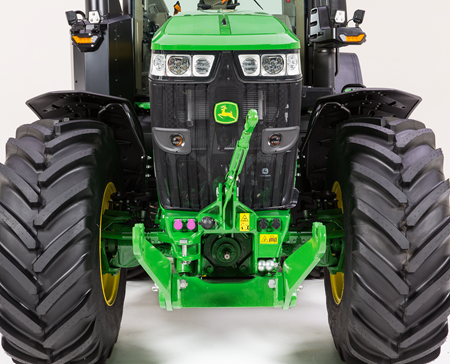 Front PTO
Front PTO
For increased versatility, two 1000-rpm front PTO options are available from the factory for 7R and 8R Series Tractors equipped with the John Deere front hitch.
- Type 2, 1000-rpm (counterclockwise as seen from front), 35-mm (1 3/8-in.), 21-spline front PTO
- Type 3, 1000-rpm (counterclockwise as seen from front), 45-mm (1 ¾-in.) 20-spline front PTO (available through Parts only)
Front PTO features include:
- The ability to be incorporated with iTEC™ sequences
- Three choices of engagement modulation: auto, low, and high
- Integrated controls
- Cornerpost display indicators
- Bolt-on shaft makes it easy to change shafts if necessary.
- Remote PTO engagement
7R specific features:
- 130 kW (175 hp)
- Integrated with all transmissions
- PTO disconnect for efficiency
- Requires Triple-Link Suspension (TLS™) front axle
8R specific features:
- 112 kW (150 hp)
- Integrated with the infinitely variable transmission (IVT™)
- Requires Independent-Link Suspension (ILS™) with front brakes
Intelligent Power Management (IPM)
IPM is compatible with 7R and 8R Series Tractors equipped with a front PTO option. The front PTO, rear PTO, or transport speeds can activate IPM on 7R Tractors. However, on 8R Tractors, IPM is only activated by the rear PTO or by transport speeds. For example:
- A front snow blower will not benefit from IPM on an 8R since the front PTO alone will not activate IPM.
- A triple-mounted mower-conditioner will benefit from IPM as high power levels are transmitted via the rear PTO. The front mower-conditioner will have 112 kW (150 hp) available to it on an 8R, which is adequate to operate these mowers in most crop conditions.
- See Intelligent Power Management for more information.
PTO disconnect on 7 Family Tractors
Disconnecting the PTO drive to the PTO box when not in use increases tractor efficiency by reducing:
- Power requirements, which saves nearly 70 percent of power required to run the PTO disengaged
- Wear on components of the PTO box; components are not moving when the PTO is disconnected
Refer to the Operator’s Manual for instructions on how to disconnect the PTO when not in operation.
Front PTO operation
 Remote control at front of tractor
Remote control at front of tractor
Front PTO engagement is actuated through an engagement switch similar to the rear PTO located on the CommandARM™ controls.
- PTO clutch is electronically activated with automatic torque modulation.
- PTO modulation is selectable through the CommandCenter™ display.
- To activate the PTO remotely, select the remote PTO enable button in Generation 4 CommandCenter display, push down and forward on the front PTO switch in the cab and use the remote control at the front of the tractor.
NOTE: For the 8R Series, if the tractor is equipped with a front PTO, additional IPM power will transfer through the front PTO. However, IPM activation is only sensed through the rear PTO. Adequate load must be sensed on the rear PTO in order for IPM to activate.
Gold Key Program Waterloo operations


The John Deere Waterloo Operations Gold Key Program was designed to recognize and honor those purchasing Waterloo-built tractors. The Gold Key tour provides an opportunity for a customer to follow his or her tractor as it is built on the assembly line. If a Gold Key customer is unable to visit the day the tractor is on the assembly line, the customer may elect an alternative date within 90 days to schedule a tour. This will be recognized as a Gold Key experience where the customer adopts a tractor to follow rather than watch his or her own tractor being built. After 90 days, the visit will be deemed a VIP tour and Gold Key memorabilia will not be provided.
Definition of a Gold Key tour
A Gold Key tour entails an exclusive, behind-the-scenes guided tour of the assembly production lines. The customer, or product owner, may bring up to three additional guests on the tour. Tour participants will wear Gold Key owner identification bump caps and other personal protective equipment while being escorted privately by a tour guide. Every attempt will be made to make sure the customer will see the specific tractor ordered come off the final assembly line; however, in order to satisfy delivery needs, the first priority is to keep the manufacturing lines running at full capacity.
The Gold Key visit date is based on when the customer’s tractor is expected to reach the final line. It is John Deere’s goal that a customer drives his or her tractor off the final line at the end of the tour. It is imperative to notify the John Deere dealer from whom the tractor was purchased in order to initiate a Gold Key tour. The John Deere dealer will be required to register guests on the Gold Key registration website as soon as possible if a Gold Key visit is requested. The owner will be presented with a gold key, a certificate, and other memorabilia at the conclusion of the factory visit. Breakfast and lunch will also be provided the day of the tourisit.
Process of Gold Key tour
The owner will need to notify the John Deere dealer where the Waterloo-built 6000 Series – 9000 Series Tractor was purchased. The Gold Key coordinator will be the sole contact with the dealership representative to make visit arrangements and confirmations for the visit.
Shortly after the Gold Key coordinator confirms the request, all appropriate paperwork and information will be sent to the dealer. The customer will then receive all welcome documents in the mail. The Gold Key coordinator will also make direct contact with the customer to confirm the visit.
 Ahrens Farms
Ahrens Farms

Ahrens Farms of Owatonna, MN participated in the Gold Key Tour at John Deere Waterloo Works in 2015. They purchased a 9470RT Tractor.
While every attempt will be made, and the factory will do everything possible to allow a customer to see his or her tractor being built, production schedules change for many reasons. Should production change at the last minute, the owner may arrive only to find that either the tractor has been pushed back or pulled ahead and already built. While that is certainly not the intention, the possibility remains.
The factory cannot be responsible for:
-
Production delays, work ahead, or production revisions
-
Any option changes at the factory level
-
Overnight accommodations; however, assistance with information is available upon request
-
Travel costs
Gold Key Tour guidelines
- All Gold Key tours must be initiated by the selling John Deere dealer through the Gold Key profile request form.
- The Gold Key coordinator at the Waterloo Tractor Factory will be responsible for updating the customer and dealer of the tractor build status.
- Gold Key treatment will not be recognized if any of the requirements are not met prior to arrival at the factory.
- The Gold Key Program is only available within 90 days of the tractor's build date.
- Every attempt will be made to make sure the customer will see his or her tractor come off the assembly line; however, the factory has first priority for production obligations.
- Gold Key tours are limited to the customer and three other persons, no more than four people total (excluding dealer).
- All guests attending Gold Key tours must be 13 years of age or older. Any teenage children must be accompanied and under constant supervision of a parent and/or guardian.
- No personal cameras or video cameras are allowed on the production floor during the tour. A camera from John Deere will be given to Gold Key guests for the duration of the tour.
- Tour participants must abide by all factory tour safety rules and regulations.
- Gold Key tours will be restricted if maximum tour capacity has been reached due to previously scheduled tours or special events.
Take advantage of the Generation 4 CommandCenter™ display, designed for efficiency
The Generation 4 CommandCenter was designed to provide a consistent user experience by providing full-screen viewing of more run page modules, shortcut keys, and precision agriculture capabilities.
Expect easier set-up, along with increased operator confidence, thanks to a simple, customizable interface. The improved design of the Generation 4 CommandCenter also aids in an optimal operating experience and maximizes uptime.
In order to increase your efficiency, take advantage of the following features offered by the Generation 4 CommandCenter:
Layout manager
 Layout manager selection page
Layout manager selection page
 Layout manager module build
Layout manager module build
- Easily create page views that meet your needs and that are also equipped with default run pages.
- Users and access allow the owner or manager to lock out certain functions to prevent operators from accessing or changing settings with a defined four-digit code.
- Gather on-screen help by selecting the help icon on the shortcut bar on the bottom of every page.
Machine monitor
 Machine monitor page
Machine monitor page
- The Machine Monitor application provides you instantaneous readings about the status or condition of your machine.
- This application shows parameters such as engine speed, coolant temperature, and ground speed.
Work monitor
 Work monitor page
Work monitor page
- The Work Monitor application displays performance information about the task being performed by the machine.
- You are shown averages, totals, and productivity of the machine, such as area worked, average working speed, and fuel usage.
- Work setup places the settings needed to properly setup features such as AutoTrac, Documentation, and Section Control in a single location. Settings include:
- Client, farm, and field
- Crop type
- Machine and implement dimensions
- Variety/hybrid and planting/seeding rates
- Variable rate prescriptions
- Product and application rates
- Application rates through the implement screens
Video capability
- Machines equipped with a 4200 CommandCenter are equipped with one video input, and the 4600 CommandCenter has four video inputs.
- You have the ability to set a variety of triggers. With each trigger, the image will then appear on the display.
Flags
 Create flags to mark items in the field
Create flags to mark items in the field
- Mark areas in the field that need special attention such as rocks, tile lines, or weed pressure.
- Flags previously recorded on the Gen 4 or GreenStar™ 3 2630 Display can be transferred between monitors.
- Flags previously recorded on the Gen 4 or GreenStar™ 3 2630 Display can be transferred between monitors.
Field boundaries
 Boundary creation from coverage
Boundary creation from coverage
 Headland creation
Headland creation
- Manually drive field boundaries with the Generation 4 CommandCenter or import existing boundary information from the GreenStar 3 2630 Display or John Deere Operations Center. Gen 4 documentation data can be used to create boundaries from coverage within the John Deere Operations Center.
Dual-display mode
 Dual display
Dual display
- Generation 4 CommandCenter may be configured to run with the following John Deere displays connected at the cornerpost of a John Deere tractor:
- GreenStar 2 1800 Display
- GreenStar 2 2600 Display
- GreenStar 3 2630 Display
- 4640 Universal Display
- 4240 Universal Display
NOTE: Vehicle applications will always be located on the Gen 4 CommandCenter.
Automatic base station switching
 Setup base stations in Fields and Boundaries applications
Setup base stations in Fields and Boundaries applications
- Customers using John Deere RTK Radio 450 or 900 can link a base station to a desired client,/ farm,/ or field. This allows automatic switching to the associated base station when changing fields. The ability to import base station assignments into Operations Center and send back to machines will be available at a later date.
Video looping supported with Gen 4 4600 CommandCenter Display and 4640 Universal Display
 Scan through videos with video looping
Scan through videos with video looping
- This feature enables users to scan or loop through all of the available video feeds for a specified duration. The default scan time is set to 7 seconds per image. The scan time is customizable per image allowing for consistent visibility to all video feeds.
Features
Lighting packages provide 360 degrees of coverage for maximum productivity
 Premium lights
Premium lights

The 7R, 8R, and 8RT Series Tractors feature two lighting package options:
- Standard
- Premium
The cab lighting pattern provides 330 degrees of coverage while the hood lighting provides the remaining 30 degrees for completely programmable 360-degree, stadium-style lighting. This ensures there are no dead zones or lighting adjustments needed. The lighting configurations are available to match various applications and ensure maximum around-the-clock productivity.
Bulb housings are large, allowing for optimum total lumens and available light. The standard lighting packages use 65-W halogen bulbs, whereas the premium lighting package uses light-emitting diode (LED) lights. In the premium lighting package, these tractors take advantage of the high-performing and efficient LED technology.
The low- and high-beam driving/work lights are adjustable. Please refer to the electrical section in the operator’s manual for complete details on adjusting lights.
 7R/8R/8RT lighting
7R/8R/8RT lighting

Yellow circles
- All lighting packages: 65-W halogen: road low beam
Red circles
- Standard: 65-W halogen
- Premium: LED
Blue circles
- Standard: 65-W halogen; field and road high beams
- Premium: LED
Orange circles
- Standard: blank
- Premium: LED
|
Standard lighting
 Standard lighting (8R)
Standard lighting (8R)
 Standard lighting (7R)
Standard lighting (7R)
Six front grill-mounted lights:
- Two 65-W low-beam driving/work lights (mid grill screen)
- Two 65-W high-beam driving/work lights (top of grill screen, hood mounted)
- Two front corner-facing halogen work lights (top of grill screen, hood mounted)
10 cab roof-mounted lights:
- Two rear-facing 65-W floodlights
- Four side-facing 65-W floodlights
- Four corner-facing amber lights
Other lights:
- Two rear fender-mounted floodlights
- Two rear turn signal and brake/tail lights (fender mounted)
- Two folding-extremity lights
Plus these lights:
- Two adjustable front roof 65-W halogen floodlights
- Two front belt-line floodlights
- Rotary beacon light
Premium lighting
Eight front grill-mounted lights:
- Two 65-W low-beam halogen driving/work lights (mid grill screen)
- Two LED high-beam driving/work lights (top of grill screen, hood mounted)
- Two front corner-facing LED work lights (top of grill screen, hood mounted)
- Two front-facing LED working lights (top of grill screen, hood mounted, inner position on the sides)
12 cab roof-mounted lights:
- Four side-facing LED lights
- Four corner-facing amber lights
- Two rear-facing LED lights
- Two adjustable front roof LED lights
Other lights:
- Two rear fender-mounted LED lights
- Two rear turn signal and brake lights (fender mounted)
- Two folding-extremity lights
- Two front belt-line LED floodlights
- Rotary beacon light
The premium lighting package replaces all previous halogen and HID lights with LED lights. The only lights that are not LED are the low-beam driving lights, they remain halogen. This allows each LED light to work at a lower temperature and no one light works harder than any other. The uniformity in LED coverage allows only one type of light output surrounding the tractor.
The lighting pattern in the premium package provides industry-leading performance in nighttime visibility. LED bulbs provide maximum brightness and a true color output for excellent field definition that is easy on the operator's eyes.
The LED lights provide 40 percent greater coverage width and 10 percent more light coverage in the rear. LED lighting packages use 45 percent less amps than standard halogen lights and have an increased life expectancy over HID lights which leads to lower costs of ownership over the life of the tractor.
NOTE: Lighting packages may vary depending on region.
Selecting a lighting mode/programmable lighting
 Lighting mode selector
Lighting mode selector

Operators can quickly select a lighting mode on the steering console:
- Lights, off position
- Road lights
- Field lights
 The CommandCenter™ display
The CommandCenter™ display
The CommandCenter display allows operators to customize light settings. Operators can select only the lights they need or want for a given application and store these settings. The operator-programmed configurations can then be turned on or off with the push of a button on the CommandARM™ controls.
- Programmable field lights 1
- Programmable field lights 2
- Beacon light
- Emergency flashers
NOTE: Road/loader lights are also referred to as high-mounted driving lights for use in front hitch applications that obscure the headlights. See the Attachments section.
The battery power saver feature is also standard. When the engine is off and the outside lights have been left on, this feature is designed to avoid battery run down.
After the lights have been left on for 30 minutes and the key is in the off position, the lights cycle or blink on and off five times as an alert. The lights continue to illuminate for one more minute and then automatically shut off to protect the battery.
Programmable exit lighting
Another feature is programmable exit lighting. Exit lighting allows the lights outside the cab to stay on for up to 300 seconds. They can be programmed in increments from 0 to 300 seconds.
Refer to the operator’s manual for complete instructions on programming field, driving, and exit lighting.
Field-installed options
Field-installed options are also available. To find this information, use the Build Your own Configurator application for US/Canada or Build & Price in John Deere Sales Centre for Australia/NZ.
| Option code | Description |
| 7201 | Standard lighting |
| 7206 | Premium lighting |
ActiveCommand steering (ACS™) provides a robust and full-encompassing steering system
ACS overview
 8R in transport
8R in transport

With ACS, John Deere has designed one of the most robust and full-encompassing steering system in the industry. Whether in the field or on the road, ACS reduces steering effort, which can result in reduced operator fatigue and can improve operator comfort.
There are four key features of the ACS system:
Dynamic road wheel offset:
- A gyroscope senses tractor yaw and can automatically make small steering adjustments to provide unprecedented line-holding abilities. Drive down a bumpy road and experience how ACS makes it easier to keep the tractor straight, even over rough terrain. ACS delivers the ultimate in comfort.
- ACS works to prevent over-steering when a sudden obstacle causes the operator to make a quick steering reaction.
Variable ratio steering:
- Approximately 3.5 turns lock-to-lock at in-field speeds for quick headland turns.
- Approximately 5 turns lock-to-lock at transport speeds.
Elimination of steering slop and hand wheel drift:
- Steering wheel drift and slop are eliminated with the ACS electronic control system.
Variable effort steering:
- Steering wheel resistance automatically changes with ground speed to deliver light steering effort at slower speeds for less effort during headland turns, and higher steering wheel torque at transport speeds for better comfort.
A fail operational system
The ACS system is fail operational, which means steering is still functional in the event of any single-point failure. John Deere has gone to great lengths to help ensure the operator has the ability to steer the tractor if something goes wrong in the steering system.
For example, if the primary controller fails, a second controller takes over. If power from the alternator fails, the battery resumes control. If the engine quits running and is unable to supply hydraulic oil to the system, an electric-driven backup pump is used to supply the oil. There is a backup for ACS components.
 ACS components
ACS components

The ACS system consists of several key components:
- Gyroscope: this is used to measure the yaw rate (turn rate) of the tractor during transport speeds.
- Road-wheel angle sensors: these sensors simply measure the steer angle of the tractor.
- Power supply module: this module distributes the power of the battery and alternator throughout the ACS system.
- Hand-wheel angle sensors and tactile feedback unit: this includes the steering wheel position sensors and a brake which can increase or decrease resistance dependent on speed. Lighter feedback is desired during normal field use, and slightly heavier feedback is desired during transport and while the tractor is cornering at high speeds.
- Controllers: two controllers are located in the back of the tractor and are the brains of the system.
- Control valves: also known as steering valves, control valves are used to steer the tractor.
- Electric-drive backup pump: this pump supplies oil to the steering system, brakes, and park (for towing) brake if there is no longer a sufficient oil supply to the steering and brakes.
Value of ACS
- Improves line holding when driving at transport speeds
- Fewer turns lock-to-lock: 3.5 turns lock-to-lock in the field for quicker headland turns and 5 turns lock-to-lock at transport speeds
- Eliminates hand wheel backlash and drift
- Reduces steering effort results in reduced operator fatigue
- Smaller hand-wheel diameter for improved operator comfort and visibility
- Maintains operator feel and touch-points of traditional steering column system
- Fully integrates with AutoTrac™ guidance assisted steering stems
- Compatible with suspended and non-suspended front axles
- Compatible with wide and narrow section width tires
Independent-Link Suspension (ILS™) utilizes industry-leading technology
 8R Series Tractor equipped with ILS
8R Series Tractor equipped with ILS
 Close-up view of ILS design
Close-up view of ILS design
The John Deere ILS utilizes industry-leading technology to supply unsurpassed gains to end-user productivity. This innovative design incorporates proven suspension design with mechanical front-wheel drive (MFWD) axle components that use state-of-the-art technology specifically for heavy equipment usage.
The ILS front axle is available on all 8R Series Tractor models.
42-km/h (26-mph) and 50-km/h (31-mph) front axles
Feature |
ILS |
Hydraulic differential lock |
Yes |
Limited slip |
No |
Suspension |
Yes |
Brakes |
Yes (optional on 42 km/h [26 mph]) |
Tire ratio/steps allowed |
5 or 6 |
Duals |
Yes |
Tread spacing singles* |
1574 mm - 2184 mm |
Tread spacing singles |
1524 mm - 2235 mm |
Singles with duals |
1524 mm - 2235 mm |
Duals |
2946 mm - 3658 mm |
Top speed |
42 km/h (26 mph) or 50 km/h (31mph) depending on model |
Front power take-off (PTO) |
Optional |
* Based on wheel equipment shipped to some geographic regions.
The ILS system gets more power to the ground because the front tires maintain ground contact pressure. This improves field and transport ride plus increases ballasting flexibility and drastically decreases the tendency to power hop.
 ILS cutaway
ILS cutaway
The ILS axle maintains minimum oil levels in the front differentials to assist in providing overall tractor operating efficiency.
John Deere ILS has three systems:
- A mechanical system
- A hydraulic system
- An electrical system
Mechanical system
The mechanical system is further broken down into the mechanical drive system and mechanical suspension system.
The mechanical drive system includes:
- A three-position switch is included on a MFWD clutch.
- The MFWD clutch has six clutch discs and separator plates that can transfer as much as 40 percent of the tractor power through to the front ILS axle.
- The front differential transfers power from the engine to the individual right and left driveshaft through a ring and pinion.
- A hydraulically engaged front differential lock containing eight clutch discs and eight separator plates works in conjunction with the rear differential lock to assist the tractor in tough, wet conditions with increased power transfer to all wheels.
- A right and left constant-velocity telescoping driveline provides smooth power transfer to the outboard hubs.
- On 8245R, 8270R, 8295R, and 8320R Tractors, the ILS driveshaft speed is 6:1. On 8345R, 8370R, and 8400R Tractors, the ILS driveshaft ratio is 8:1. By using an 8:1 ratio on higher horsepower tractors, power can get to the wheels while minimizing the torque the U-joint experiences.
The mechanical suspension system consists of large cast, upper- and lower-control arms with cast steering knuckles for durability and reliability.
- There is a high steering capacity, even with dual wheels – 25 percent increase over model year 2013
- High torque in all steering positions provides maximum transfer of power to the wheels under all conditions
- Fully independent suspension maintains optimum ground contact at all times
Hydraulic system
The hydraulic system consists of suspension cylinders, a control valve manifold, a front differential lock, and hydraulic accumulators.
- There is a high steering capacity through large steering cylinders.
- Responsive link arms maintain contact with the ground surface, giving maximum tractive performance under any condition.
- Accumulators dampen energy from bumps to produce a smooth ride for maximum operator comfort.
Electrical system
The electrical system contains position sensors, solenoids for the control valves, and a master controller for complete automatic control of the ILS system.
How does it work?
The mechanical, hydraulic, and electrical systems work together to maintain a level and vertically-centered position of the front differential case in relation to the outboard hubs and planetaries, independent of tractor weight or dynamic loading. The system's ability to maintain a vertically centered position provides full suspension travel of 25.4 cm (10 in.). This translates to consistent soil contact for improved power to the ground as well as dampens the energy from bumps that cause a rough ride.
The tractor utilizes electronic and computer controls that monitor tractor functions and axle position. Based on those inputs, the electrical system automatically triggers hydraulic functions to raise, lower, or remain static.
The John Deere ILS uses a short/long A-arm design, which means the upper control arms are shorter than the lower control arms. During wheel movement, the upper control arm moves in a smaller arc than the lower control arm, and the difference in the two arcs creates a change in camber. The change in camber helps keep the inside and outside of the front tires perpendicular to the drive surface, a very important feature when optional front dual wheels are installed. This design provides anti-dive characteristics to naturally reduce the adverse effects of braking and acceleration.
The John Deere ILS front axle has been specifically designed to accommodate additional options, such as front 3-point hitches and front duals. To properly handle these options, large steering cylinders and knuckles provide up to twice the steering capacity of the standard MFWD beam axles so steering performance is maintained. A simple steering stop arrangement offers infinite adjustability for fine-tuning in any row spacing.
Braking system
With higher speeds and expected heavy towed implements and carts, front brakes are optional on 42-km/h (26-mph) ILS-equipped tractors and part of base equipment on 50-km/h (31-mph) ILS-equipped tractors. The braking system is applied proportionally between the front and rear axle brakes to effectively stop the tractor. There are no operator adjustments or requirements to operate the additional braking system.
Tire compatibility
For travel speeds of 50 km/h (31 mph), B-speed-rated tires that provide high-speed capabilities are required.
With the ability to have a six-step drop from rear to front tire, the 8R equipped with an ILS axle is able to have group 49 rear tires with group 43 fronts. This allows for the benefits of group 49 tires while maintain the turning radius allowed by group 43 front tires.
NOTE: The use of group 44 tires for front duals does not allow for some row crop spacings.
Front duals
 8R Series Tractor with front duals
8R Series Tractor with front duals
 Narrow-diameter extension and hub attachment
Narrow-diameter extension and hub attachment
Front dual tires provide:
- Ultimate flotation and compaction management
- Increased load-carrying capacity
- Easy installation or removal; no need to remove the inner tire
- Bolt-on components versus studded flanges for superior flexibility for dual/no dual applications.
- Narrow hub extensions to ensure superior crop clearance for row crop applications
- A serviceability port has been added to eliminate the need to remove the front dual and hub in order to change the hub oil at the required service interval
Hitch application
In hitch applications, it is important to maintain at least 50 percent of the ballasted front-axle weight (with implement raised) for steering control. Referring to the example below, the maximum ballasted weight of the front axle is 7756 kg (17,100 lb). If the tractor has a hitch-mounted implement, when the tractor is weighed with the hitch and implement fully raised, the front weight must be at least 3878 kg (8550 lb). The front axle capacity is directly proportional to the weight that can be carried on the hitch.
The MFWD axle has a front weight carrying capacity equal to the front tire carrying capacity. For example, in row-crop applications using the popular 480/70R34 (155 load index) front tires, the highest load rating is 3878 kg (8550 lb) per tire with a total of 7756 kg (17,100 lb) at maximum tire pressure. This means (depending on tire pressure and speed) there is as much as 3878 kg (8550 lb) available for support of rear implements in transport.
Maximum load carrying capacity of the axle is determined by the load carrying capacity of the tires and whether the tractor is equipped with singles or duals.
Additional ILS features:
There is no on/off switch for ILS operation since the John Deere advanced electronic management system knows when to disengage ILS automatically. The electronic controller will activate a restricted mode of operation, when any of the following conditions are met:
- Both brake pedals are pushed
- The 3-point hitch raise/lower switch is activated
- The tractor is placed in park
- Wheel speed is less than 0.5 km/h (0.3 mph)
- Tractor is correcting for an out-of-level condition
Based on the inputs received (speed, suspension displacement, braking and operator input to hitch and/or remote cylinders), the tractor determines when the system should be active or inactive, making operation simple and efficient.
MFWD CommandARM™ controls for ILS
Shortcut keys on the CommandARM enable the operator to engage or disengage MFWD on the go, even under full load, without stopping or clutching. The switch can be placed in one of the following positions:
1. AUTO
2. On
3. Off (brake assist)
Mode 1 - AUTO
 AUTO light
AUTO light
When this light-emitting diode (LED) light is lit, MFWD is on but automatically disengages when either of the following conditions are met:
- Either brake pedal is depressed and held to allow tighter turns
- Transporting at speeds above approximately 23.0 km/h (13.8 mph) to reduce tire wear; automatically engages when speed drops below 19.0 km/h (11.4 mph)
- When the front wheel turn angle meets an operator-defined point
As with the brake-assist position, when both brakes are depressed, the MFWD automatically engages (if not already on) to provide four-wheel braking.
 Automatic MFWD angle adjustment
Automatic MFWD angle adjustment
Mode 2 - MFWD on
 MFWD light
MFWD light
When this LED light is lit, MFWD engages continuously.
Mode 3 MFWD off (brake assist)
When no LED lights are lit, the MFWD is off. This is also referred to as the brake-assist position. Even though the MFWD is disengaged, when both brakes are pressed at speeds above 5 km/h (3 mph), the MFWD engages to assist braking the tractor.
Differential lock
 CommandARM™ controls with automatic differential lock engaged
CommandARM™ controls with automatic differential lock engaged
 CommandARM controls with manual differential lock engaged
CommandARM controls with manual differential lock engaged
The differential lock is another feature of the ILS axle. When the rear differential lock is engaged or disengaged, the front differential lock is also engaged or disengaged. This also includes a driveline shield.
If one wheel begins to slip, the differential lock can be engaged on the go and the axles are hydraulically locked together for maximum traction. There are two ways to engage the differential lock feature.
- Manual differential lock - differential lock can be engaged manually using a switch on the floor or by manually depressing a button on the CommandARM console. When brakes are depressed, the differential lock will disengage
- Automatic differential lock - when in auto mode, differential lock is engaged when the tractor is driving forward. Differential lock will disengage when front wheel turn angle meets disengage wheel angle setting defined by the operator via the CommandCenter or when either brake pedal is depressed. Differential lock will automatically engage when brakes are released or front wheels are turned straight.
 Automatic differential lock angle adjustment
Automatic differential lock angle adjustment
Additional equipment for use with ILS axle
- 3M front axle spacing kit:
Front axle static weight for the ILS axle shall not exceed 6759 kg (14,900 lb) using the 3M kit - H480 Front Loader
Refer to the material handling section for additional information.
Hydraulic pump options to meet varying flow requirements
All 8R and 8RT Series Tractors come standard with an 85-cc displacement integrated hydraulic pump. This pump provides 227.1 L/min (60 gpm) of hydraulic flow.
A dual-pump option, featuring 85-cc and 35-cc displacement hydraulic pumps, is available for all 8R wheel models. The dual-pump system provides a hydraulic flow of 321 L/min (85 gpm), ideal for running at lower engine speeds.
SCV flow (approximate) |
||
Engine rpm |
Pump flow (85-cm3 pump) L/min (gpm) |
High pump flow (85-cm3 pump + 35-cm3 optional pump) L/min (gpm) |
800 |
86 (23) |
122 (32) |
1500 |
162 (43) |
229 (61) |
1700 |
184 (49) |
260 (69) |
1900 |
206 (54) |
290 (77) |
2100 |
227 (60) |
321 (85) |
Operating the tractor at reduced engine rpm contributes to a quieter cab, reduced fuel usage, and maintains the vacuum while turning and raising the planter on end rows. At 1500 erpm with a 321 L/min (85 gpm) system there will be an available flow of 229 L/min (61 gpm). This is an improvement over an available 162 L/min (43-gpm) flow when operating with a 227 L/min (60 gpm) system at 1500 erpm.
The maximum flow through one selective control valve (SCV) with a standard coupler is 132 L/min (35 gpm). A 19.1-mm (3/4-in.) high-flow coupler allows for a maximum flow rate out of one SCV of 153 L/min (40.5 gpm).
The hydraulic system is a closed-center, power-on-demand system using a load-sensing pressure-flow compensated axial piston pump with full-flow charge and flow prioritization for steering and brakes.
The pump outlet pressure available on demand can range from 3000 kPa (435 psi) for track models and 4000 kPa (580 psi) for wheel models at low standby to 20,400 kPa (2958 psi) at high standby.
Hydraulic pump options:
- 85-cc displacement, 227-L/min (60-gpm) hydraulic pump
- NOTE: Standard on all 8R models.
- 85-cc and 35-cc dual pump option, 321-L/min (85-gpm)
- NOTE: Compatible with 2014 Final Tier 4 (FT4) and newer 8R Wheel Tractors only.
Standard CommandView™ III cab offers unsurpassed amenities
 CommandView III cab
CommandView III cab
The Standard CommandView III cab offers unsurpassed visibility, operator comfort, control placement, and ride and sound quality.
Features:
- ComfortCommand™ seat with air suspension, lumbar support, swivel, fore-aft and lateral attenuation, backrest angle adjustment, adjustable left-hand armrest, and 40-degree right-hand seat swivel
- Operator presence system that warns if the operator is out of the seat while operating key functions
- Folding instructional seat
- CommandARM™ console with integrated controls
- 4100 or 4600 Generation 4 CommandCenter™ display
- Behind-the-seat storage
- Left-hand storage compartment
- Passive noise reduction system
- Service ADVISOR™ data port
- Tilt/telescoping steering wheel with position memory
- Swing-out rear window that opens 30 degrees
- Right- and left-outside mirrors (manually adjustable mirror head)
- Monitor mounts on right-hand front post and rear cab post
- Standard radio package, including AM/FM stereo and weatherband with remote controls, auxiliary input jack, four speakers, and an external antenna
- Laminated glass
- Air conditioner and heater with automatic temperature controls (ATC)
- Two 12-V convenience outlet (cigarette lighter style)
- One 12-V three-pin outlet with adapter (provides switched and unswitched power)
- One International Organization for Standardization (ISO) nine-pin connector
- Power strip with convenience plug adapter
- Hitch control lever lock and selective control lever lock
- Two-speed and intermittent front and rear wiper with washer
- Front pull-down sunshade
- Digital cornerpost display with:
- Fuel level gauge, including low fuel warning
- Temperature gauge
- Diesel exhaust fluid (DEF) gauge, including low DEF warning
- Engine rpm
- Transmission commanded gear or speed
- Vehicle system functions, such as iTEC™ system, that are operating
- Inside-mounted rearview mirror
- Beverage holders sized to accommodate various containers
- Interior left-hand dome light
ComfortCommand seat
 ComfortCommand seat
ComfortCommand seat
ComfortCommand seat improves ride quality and helps to reduce operator fatigue.
Features include:
- Armrests, lumbar support, and backrest angle are easily adjusted to match operator preference.
- Shock absorbers dampen the motion effect of the tractor for an improved ride.
- Seat height adjustments are conveniently located on the left armrest.
- Fore-aft adjustment is easy to reach located on the left front of the seat.
- Swivel adjustment, located on the front of the seat, allows the seat to be swiveled 40 degrees to the right or eight degrees to the left of the center position.
- Operator presence switch warns if the operator is out of the seat while operating key functions.
- Seat belt retractor.
- Centered cab seat provides excellent over-shoulder visibility.
- Adjustable shock absorber permits ride adjustment from soft to firm to match the operator's desired comfort level.
- Removable cushions allow for easy cleaning.
 Fingertip paddle pots
Fingertip paddle pots
 Encoder wheel
Encoder wheel
CommandARM
 CommandARM controls
CommandARM controls
John Deere 7R and 8R Series Tractors feature the CommandARM with integrated Generation 4 CommandCenter display. The control layout of the CommandARM utilizes a clean and efficient design which groups controls by function and builds upon John Deere’s history of intuitive and ergonomic control placement and operation. The design of the CommandARM allows for a 40 degree right seat swivel and adjustable positioning matching the operator’s preference.
Controls located on the CommandARM include:
- Engine throttle
- FieldCruise™ system
- Minimum engine speed – CommandQuad™ transmission, 16-speed PowerShift™ transmission (PST), e23™ transmission
- Eco mode – Infinitely Variable Transmission (IVT™)
- Foot pedal lock (if equipped)
- Transmission control
- Hitch/selective control valve (SCV) controls
- Rotary encoder hitch control
- Power take-off (PTO) controls
- Mechanical front-wheel drive (MFWD) on/automatic
- Differential lock on/automatic
- iTEC sequence switches
- AutoTrac™ assisted steering system resume switch (if equipped)
- Joystick (if equipped)
- Radio
- Beacon light on/off
- Hazard lights on/off
- Field lights 1/2
- Heating, ventilation, air conditioning (HVAC) system
Transmission controls
John Deere 7R Series Tractors with CommandQuad transmissions feature a left-hand reverser. 8R Series Tractors equipped with 16-speed PST are equipped with right-hand reverser. 7R Series Tractors equipped with e23 PST offer a left- or right-hand reverser. 7R or 8R Series Tractors equipped with AutoPowr™/IVT transmissions are offered with either a left-hand or a right-hand reverser.
The transmission control lever is placed on the left side of the CommandARM closest to the operator for convenient setting and adjustment.
 Left-hand CommandQuad/e23 reverser
Left-hand CommandQuad/e23 reverser
 Right-hand IVT and PST reverser
Right-hand IVT and PST reverser
 16-speed PST right-hand reverser
16-speed PST right-hand reverser
Hydraulic and hitch controls
Hydraulic and hitch controls utilize fingertip paddle pots for raise/lower and extend/retract functions. An optional crossgate joystick replaces fingertip paddle pots for control of SCVs and allows for programmable hydraulic functionality according to operator preference. Rear hitch position can also be controlled with the encoder wheel located on the right side of the CommandARM. The encoder wheel allows for finite positioning of the rear 3-point hitch.
Three buttons near the encoder are for hitch set, lock, and return to height. Adjustment knobs for the 3-point hitch are located under the cover for the CommandARM control's storage compartment and allow for adjustment of the rate of drop, hitch height limit, and depth control.
 Hitch controls
Hitch controls
 Optional crossgate joystick
Optional crossgate joystick
Throttle
The throttle design incorporates buttons which control FieldCruise speed, foot pedal mode (if equipped), and transmission eco settings.
 Throttle
Throttle
 Foot throttle
Foot throttle
Tractor function controls
Located just to the right of the throttle is the AutoTrac activation button and four sequence controls for iTEC functions. Behind the iTEC sequence controls, there are buttons which control the activation and deactivation of MFWD and differential lock.
 AutoTrac resume and iTEC strip
AutoTrac resume and iTEC strip
Controls for radio, lights, rotary beacon (if equipped), hazard flashers, and HVAC system are located to the center-right on the CommandARM, along with PTO for both front (if equipped) and rear PTO.
 Radio, HVAC, hazard flashers, and PTO controls
Radio, HVAC, hazard flashers, and PTO controls
Seat swivel
The design of the CommandARM allows for up to 40 degrees of right-hand seat swivel.
 Seat swivel
Seat swivel
CommandCenter
 Generation 4 CommandCenter
Generation 4 CommandCenter
The Generation 4 CommandCenter features fast adjustment of tractor functions and controls and are integrated into the CommandARM to create a seamless control center. The 4100 CommandCenter features a 178-mm (7-in.) touchscreen display and is standard equipment on 7210R and 7230R models, while the 4600 CommandCenter features a 154-mm (10-in.) touchscreen and is standard equipment on 7250R – 7310R models, as well as all 8R and 8RT models.
The following functions can be adjusted using the CommandCenter display:
- Hydraulic settings
- Hitch settings
- Transmission settings
- FieldCruise
- iTEC programming functions
- Radio
- Lights
Tire options for 8R Series Tractors


John Deere 8R Series Tractors are utilized in numerous applications that place different demands on tires. As such, multiple tire offerings are available for 8R Series Tractors to accommodate a wide range of grower needs. Tire options provide variability in terms of ground clearance, tread width, and floatation to match different operating conditions.
John Deere sources 8R Series Tractor tires from the following major brands:
- Mitas® tires
- Firestone® tires
- Goodyear® tires
- Michelin® tires
- Trelleborg® tires
Tire matching (rears and fronts)
 8R Series Tractor
8R Series Tractor

Front and rear tires for 8R Series Tractors are sized and combined under different group sizes based on tire rolling circumference. All front tire options for 8R Series Tractors are classified as group 42, 43, or 44, while all rear tires are classified as group 47, 48, or 49. The approximate overall diameters for each group are shown in the following table.
| Group | Overall diameter |
| 42 | 1498 mm (59 in.) |
| 43 | 1600 mm (63 in.) |
| 44 | 1676 mm (66 in.) |
| 47 | 1955 mm (77 in.) |
| 48 | 2057 mm (81 in.) |
| 49 | 2172 mm (85.5 in.) |
For tractors with mechanical front-wheel drive (MFWD) or Independent-Link Suspension (ILS™) front axles, there typically needs to be five steps (or group size difference) between the front and rear tires to maintain proper tire overspeed between axles. This means the group 42 front tire needs to be matched with group 47 rear tire, and group 43 front tire needs to be matched with group 48 rear tire.
On 1500 MFWD axles, four-step combinations between front and rear tires are also acceptable (determined at the time of ordering the tractor). This means group 44 front tire can be matched with group 48 rear tire, or group 43 front tire can be matched with group 47 rear tire. Six step combinations are possible on tractors equipped with ILS, allowing group 43 front tires to be paired with group 49 rear tires in order to maintain narrower tread functionality with row crop width tire options.
Additionally, tires have a load index rating designed to report the load carrying capability of the tire.
Group 49 rear tires


John Deere 8R Series Tractors are now approved for group 49 rear tires. Group 49 tires have a larger diameter and longer footprint, which results in greater traction in most field conditions compared to smaller group size tires of the same section width and basic design. Group 49 tires also provide a larger air volume than comparable smaller group sizes, which can help control power hop in some conditions.
NOTE:
- Front tread spacing for group 49 tires (group 44 fronts) has to be 1930 mm (76 in.) or wider based on tire size. For 762-mm (30-in.) tread spacings, tractors equipped with ILS may be equipped with group 49 rear tires and group 43 front tires.
- 710/75R42 (group 49) tires are available in singles only (see Configurator for complete offering)
- 480/95R50 (group 49) tires are available in duals only (see Configurator for complete offering)
- Operators will experience a decrease in turning radius with group 49 tires due to the larger-diameter group 44 front tires.
Row width guidelines
Multiple tire options are available for 8R Series Tractors to accommodate multiple applications or row widths. Refer to the minimum recommended row widths for tire options based on the row-width requirements in the following table.
NOTE: Not all tires listed in the chart are available on all John Deere tractors. See your local John Deere dealer for assistance in choosing the proper tires for specific tractor models.
Rear tires |
Minimum recommended row width |
|||||||
508 mm |
559 mm |
762 mm |
813 mm |
1016+ mm |
||||
Rear tire section width |
||||||||
RCI Group |
Approximate outside diameter |
320 mm |
380 mm |
480 mm* |
520 mm* |
620 mm |
710 mm (28.0 in.) |
800 mm (31.5 in.) |
49 |
2175 mm |
|
|
480/95R50 |
|
|
710/75R42 |
|
48 |
2057 mm |
320/105R54 |
380/90R54 |
480/80R50 |
520/85R46 |
620/70R46 650/85R38 |
710/70R42 |
800/70R38 |
47 |
1956 mm |
320/90R54 |
380/90R50 |
18.4R46 480/80R46 |
20.8R42 520/85R42 |
620/70R42 650/75R38 |
710/70R38 |
|
*480 and 520 width tires will accommodate minimum tread setting of 33 in. with 85L oil takeout.
Hitch clearance and tread spacing
 Tread spacing
Tread spacing

To prevent draft link interference, the distance (1) between the inside edges of the tires should be:
- Category 3N hitch – 1092 mm (43 in.)
- Category 3 hitch – 1168 mm (46 in.)
- Category 4N hitch – 1168 mm (46 in.)
* Tires 480 mm (19 in.) and larger may not be able to reach all tread settings. Refer to the operator’s manual for detailed tread setting limitations.
Goodyear is a trademark of Goodyear Tire and Rubber Company.
Firestone is a trademark of Bridgestone Americas Tire Operations, LLC.
Michelin is a trademark of MNA, Inc.
Mitas Tires North America is a registered subsidiary of MITAS a.s.
Trelleborg is a trademark of Trelleborg Wheel Systems, Inc.
| Front tires | Minimum recommended row width | |||||||
| 508 mm (20 in.) |
559 mm (22 in.) |
762 mm (30 in.) |
813 mm (32 in.) |
1016+ mm (40+ in.) |
||||
| Front tire section width | ||||||||
| RCI Group | Approximate outside diameter | 290 mm (11.4 in.) |
320 mm (12.6 in.) |
380 mm (15.0 in.) |
420 mm (16.5 in.) |
480 mm (18.9 in.) |
520 mm (20.5 in.) |
620 mm (24.4 in.) |
| 44 | 1676 mm (66 in.) |
540/75R34 | 620/75R30 | |||||
| 43 | 1600 mm (63 in.) |
320/80R42 | 380/80R38 | 420/85R34 | 480/70R34 | 540/65R34 | 600/70R30 | |
| 42 | 1499 mm (59 in.) |
320/85R38 | 380/85R34 | 16.9R30 420/90R30 |
480/70R30 | 540/65R30 | 600/65R28 | |
Please reference the operator’s manual for tread spacing requirements.
Rear power take-off (PTO) options
 45-mm (1-3/4-in.), 1000-rpm PTO
45-mm (1-3/4-in.), 1000-rpm PTO
All 8R and 8RT Series Tractors come standard with a fully independent 45-mm (1-3/4-in.), 1000-rpm PTO. This 20-spline shaft is designed for high-power, heavy PTO loads that require full horsepower above 150 PTO hp.
The 8R Series Wheel Tractors offer additional mechanical and electrical speed-change PTO options to provide the versatility and flexibility needed to satisfy implement demands. An in-cab shiftable, eco version of the 45-mm (1-3/4-in.), 1000-rpm PTO is available, allowing full PTO rotations at decreased engine speeds.
Additionally, a 45-mm (1-3/4-in.), 1000-rpm PTO capable of 35 mm (1-3/8 in.), 540-rpm (6 spline)/1000-rpm (21 spline) can be ordered. To field convert to the 35-mm (1-3/8-in.) 540/1000-rpm PTO, a field kit is required (the required shaft is dependent on the hitch option).
NOTE: 540-rpm PTO options are not compatible with the Category 4 drawbar.
The PTO activation switch is located on the CommandARM™ controls. In addition, PTO engagement modulation is adjustable with settings located in the CommandCenter™ display. The PTO shaft can be slightly rotated or indexed to aid in PTO drive hookups. All PTO options feature internal lubrication with heavy-duty oil-cooled clutch plates. A PTO safety start system and seat-activated PTO warning is standard on all 8R and 8RT Series Tractors.
The following tables show when shaft kits are required for each PTO shaft based on the selected hitch option (drawbar, 3-point hitch, 80-mm ball/piton).
1000/540 PTO |
||||||
| PTO type | Nominal diameter, mm | Number and type of splines | PTO speed (rpm) | Drawbar | 3-point hitch | 80-mm ball/piton |
| 1 | 35 | 6 straight splines | 540 | RE272736 | RE272736 | R538037 |
| 2 | 35 | 21 involute splines | 1000 | RE272736 | RE272736 | R537791 |
| 3 | 45 | 20 involute splines | 1000 | OK from factory | OK from factory | OK from factory |
1000/1000E PTO |
||||||
| PTO type | Nominal diameter, mm | Number and type of splines | PTO speed, rpm | Drawbar | 3-point hitch | 80-mm ball/piton |
| 1 | 35 | 6 straight splines | 540 | No solution | No solution | No solution |
| 2 | 35 | 21 involute splines | 1000/1000E | R537790 | R537790 | R313423 |
| 3 | 45 | 20 involute splines | 1000/1000E | OK from factory | OK from factory | OK from factory |
General applications:
- Use the 45-mm (1-3/4-in.), 1000-rpm PTO for full-power PTO applications, such as grain carts, rotavators, and silage choppers.
- Use the 35-mm (1-3/8-in.), 1000-rpm PTO shaft on implements requiring less than 150 PTO hp, such as manure spreaders and rotary cutters.
- Use the 35-mm (1-3/8-in.), 540-rpm PTO shaft on implements requiring less than 75 PTO hp (light loads only), such as auger applications.
NOTE: Proper engine speed for the 1000-rpm PTO shaft is 2000 engine rpm. For the 540-rpm PTO shaft, proper engine speed is 1817 rpm.
Rear PTO options:
- 45-mm (1-3/4-in.), 1000-rpm (20-spline) PTO
- NOTE: Compatible with 8R and 8RT Series Tractors.
- 45-mm (1-3/4-in.), 1000-rpm (20 spline), capable of 35-mm (1-3/8-in.), 540-rpm (6-spline)/1000-rpm (21-spline) PTO
- NOTE: Compatible with 8R Wheel Tractors.
To field convert to 35-mm (1-3/8-in.), 540/1000-rpm PTO, a kit will be required.
35-mm (1-3/8-in.), 540-rpm PTO portion of this option is not compatible with the Category 4 drawbar.
- NOTE: Compatible with 8R Wheel Tractors.
- 45-mm (1-3/4-in.), 1000-rpm and 1000E economy rpm PTO, in-cab shiftable
- NOTE: Compatible with 8R Wheel Tractors only. Not compatible with 16-speed PowerShift™ transmission (PST).
Includes 45-mm (1-3/4-in.), 1000-rpm (20-spline) shaft. See Parts for additional bolt-on shafts.
- NOTE: Compatible with 8R Wheel Tractors only. Not compatible with 16-speed PowerShift™ transmission (PST).
ActiveSeat™ seat utilizes electrohydraulic technology with air suspension
 ActiveSeat and controls
ActiveSeat and controls

John Deere’s ActiveSeat utilizes electrohydraulic technology in combination with air suspension, providing the operator with enhanced ride quality over standard air-suspension seats.
Operator movements are monitored in order to reduce vertical movement. An ActiveSeat suspension can isolate the operator from up to 90 percent of vertical movements typically seen in tractor applications.
The system uses a hydraulic cylinder that is connected to a control valve assembly. Electrohydraulic valves located in the control valve assembly automatically react to inputs from two sensors, a position sensor and an accelerometer. Inputs from these two sensors control oil flow from the tractor to the hydraulic cylinder to reduce the vertical movement of the operator.
 ActiveSeat left armrest
ActiveSeat left armrest

The John Deere ActiveSeat has many of the same features of the ComfortCommand™ seat with the addition of a ride firmness switch. The ride firmness switch is located on the left-hand armrest and replaces the suspension shock-dampening seat attenuation lever on the front right-hand side of the ComfortCommand seat controls.
The ride firmness switch has three positions: plus, minus, and mid position. The three positions provide three different levels of seat performance:
- The plus position provides the greatest degree of ride firmness. This position allows more of the tractor's inputs to be felt by the operator (slightly rougher ride).
- The minus position provides the least degree of ride firmness, allowing minimal tractor inputs to reach the operator, resulting in maximum seat performance.
- The mid position allows a balance between the plus (+) and minus (-) settings.
The ActiveSeat is also available as a heated leather seat for increased comfort and easier cleaning. For tractor applications where operating speed is not limited by the implement, the ActiveSeat can allow for faster field speeds and increased overall comfort and productivity.
NOTE: The John Deere ActiveSeat is not available on track tractors.
| Option code | Description |
| 2061 | Premium CommandView III Cab with Active Seat |
Take advantage of the Generation 4 CommandCenter™ display, designed for efficiency
The Generation 4 CommandCenter was designed to provide a consistent user experience by providing full-screen viewing of more run page modules, shortcut keys, and precision agriculture capabilities.
Expect easier set-up, along with increased operator confidence, thanks to a simple, customizable interface. The improved design of the Generation 4 CommandCenter also aids in an optimal operating experience and maximizes uptime.
In order to increase your efficiency, take advantage of the following features offered by the Generation 4 CommandCenter:
Layout manager
 Layout manager selection page
Layout manager selection page
 Layout manager module build
Layout manager module build
- Easily create page views that meet your needs and that are also equipped with default run pages.
- Users and access allow the owner or manager to lock out certain functions to prevent operators from accessing or changing settings with a defined four-digit code.
- Gather on-screen help by selecting the help icon on the shortcut bar on the bottom of every page.
Machine monitor
 Machine monitor page
Machine monitor page
- The Machine Monitor application provides you instantaneous readings about the status or condition of your machine.
- This application shows parameters such as engine speed, coolant temperature, and ground speed.
Work monitor
 Work monitor page
Work monitor page
- The Work Monitor application displays performance information about the task being performed by the machine.
- You are shown averages, totals, and productivity of the machine, such as area worked, average working speed, and fuel usage.
- Work setup places the settings needed to properly setup features such as AutoTrac, Documentation, and Section Control in a single location. Settings include:
- Client, farm, and field
- Crop type
- Machine and implement dimensions
- Variety/hybrid and planting/seeding rates
- Variable rate prescriptions
- Product and application rates
- Application rates through the implement screens
Video capability
- Machines equipped with a 4200 CommandCenter are equipped with one video input, and the 4600 CommandCenter has four video inputs.
- You have the ability to set a variety of triggers. With each trigger, the image will then appear on the display.
Flags
 Create flags to mark items in the field
Create flags to mark items in the field
- Mark areas in the field that need special attention such as rocks, tile lines, or weed pressure.
- Flags previously recorded on the Gen 4 or GreenStar™ 3 2630 Display can be transferred between monitors.
- Flags previously recorded on the Gen 4 or GreenStar™ 3 2630 Display can be transferred between monitors.
Field boundaries
 Boundary creation from coverage
Boundary creation from coverage
 Headland creation
Headland creation
- Manually drive field boundaries with the Generation 4 CommandCenter or import existing boundary information from the GreenStar 3 2630 Display or John Deere Operations Center. Gen 4 documentation data can be used to create boundaries from coverage within the John Deere Operations Center.
Dual-display mode
 Dual display
Dual display
- Generation 4 CommandCenter may be configured to run with the following John Deere displays connected at the cornerpost of a John Deere tractor:
- GreenStar 2 1800 Display
- GreenStar 2 2600 Display
- GreenStar 3 2630 Display
- 4640 Universal Display
- 4240 Universal Display
NOTE: Vehicle applications will always be located on the Gen 4 CommandCenter.
Automatic base station switching
 Setup base stations in Fields and Boundaries applications
Setup base stations in Fields and Boundaries applications
- Customers using John Deere RTK Radio 450 or 900 can link a base station to a desired client,/ farm,/ or field. This allows automatic switching to the associated base station when changing fields. The ability to import base station assignments into Operations Center and send back to machines will be available at a later date.
Video looping supported with Gen 4 4600 CommandCenter Display and 4640 Universal Display
 Scan through videos with video looping
Scan through videos with video looping
- This feature enables users to scan or loop through all of the available video feeds for a specified duration. The default scan time is set to 7 seconds per image. The scan time is customizable per image allowing for consistent visibility to all video feeds.
Features
Lighting packages provide 360 degrees of coverage for maximum productivity
 Premium lights
Premium lights

The 7R, 8R, and 8RT Series Tractors feature two lighting package options:
- Standard
- Premium
The cab lighting pattern provides 330 degrees of coverage while the hood lighting provides the remaining 30 degrees for completely programmable 360-degree, stadium-style lighting. This ensures there are no dead zones or lighting adjustments needed. The lighting configurations are available to match various applications and ensure maximum around-the-clock productivity.
Bulb housings are large, allowing for optimum total lumens and available light. The standard lighting packages use 65-W halogen bulbs, whereas the premium lighting package uses light-emitting diode (LED) lights. In the premium lighting package, these tractors take advantage of the high-performing and efficient LED technology.
The low- and high-beam driving/work lights are adjustable. Please refer to the electrical section in the operator’s manual for complete details on adjusting lights.
 7R/8R/8RT lighting
7R/8R/8RT lighting

Yellow circles
- All lighting packages: 65-W halogen: road low beam
Red circles
- Standard: 65-W halogen
- Premium: LED
Blue circles
- Standard: 65-W halogen; field and road high beams
- Premium: LED
Orange circles
- Standard: blank
- Premium: LED
|
Standard lighting
 Standard lighting (8R)
Standard lighting (8R)
 Standard lighting (7R)
Standard lighting (7R)
Six front grill-mounted lights:
- Two 65-W low-beam driving/work lights (mid grill screen)
- Two 65-W high-beam driving/work lights (top of grill screen, hood mounted)
- Two front corner-facing halogen work lights (top of grill screen, hood mounted)
10 cab roof-mounted lights:
- Two rear-facing 65-W floodlights
- Four side-facing 65-W floodlights
- Four corner-facing amber lights
Other lights:
- Two rear fender-mounted floodlights
- Two rear turn signal and brake/tail lights (fender mounted)
- Two folding-extremity lights
Plus these lights:
- Two adjustable front roof 65-W halogen floodlights
- Two front belt-line floodlights
- Rotary beacon light
Premium lighting
Eight front grill-mounted lights:
- Two 65-W low-beam halogen driving/work lights (mid grill screen)
- Two LED high-beam driving/work lights (top of grill screen, hood mounted)
- Two front corner-facing LED work lights (top of grill screen, hood mounted)
- Two front-facing LED working lights (top of grill screen, hood mounted, inner position on the sides)
12 cab roof-mounted lights:
- Four side-facing LED lights
- Four corner-facing amber lights
- Two rear-facing LED lights
- Two adjustable front roof LED lights
Other lights:
- Two rear fender-mounted LED lights
- Two rear turn signal and brake lights (fender mounted)
- Two folding-extremity lights
- Two front belt-line LED floodlights
- Rotary beacon light
The premium lighting package replaces all previous halogen and HID lights with LED lights. The only lights that are not LED are the low-beam driving lights, they remain halogen. This allows each LED light to work at a lower temperature and no one light works harder than any other. The uniformity in LED coverage allows only one type of light output surrounding the tractor.
The lighting pattern in the premium package provides industry-leading performance in nighttime visibility. LED bulbs provide maximum brightness and a true color output for excellent field definition that is easy on the operator's eyes.
The LED lights provide 40 percent greater coverage width and 10 percent more light coverage in the rear. LED lighting packages use 45 percent less amps than standard halogen lights and have an increased life expectancy over HID lights which leads to lower costs of ownership over the life of the tractor.
NOTE: Lighting packages may vary depending on region.
Selecting a lighting mode/programmable lighting
 Lighting mode selector
Lighting mode selector

Operators can quickly select a lighting mode on the steering console:
- Lights, off position
- Road lights
- Field lights
 The CommandCenter™ display
The CommandCenter™ display
The CommandCenter display allows operators to customize light settings. Operators can select only the lights they need or want for a given application and store these settings. The operator-programmed configurations can then be turned on or off with the push of a button on the CommandARM™ controls.
- Programmable field lights 1
- Programmable field lights 2
- Beacon light
- Emergency flashers
NOTE: Road/loader lights are also referred to as high-mounted driving lights for use in front hitch applications that obscure the headlights. See the Attachments section.
The battery power saver feature is also standard. When the engine is off and the outside lights have been left on, this feature is designed to avoid battery run down.
After the lights have been left on for 30 minutes and the key is in the off position, the lights cycle or blink on and off five times as an alert. The lights continue to illuminate for one more minute and then automatically shut off to protect the battery.
Programmable exit lighting
Another feature is programmable exit lighting. Exit lighting allows the lights outside the cab to stay on for up to 300 seconds. They can be programmed in increments from 0 to 300 seconds.
Refer to the operator’s manual for complete instructions on programming field, driving, and exit lighting.
Field-installed options
Field-installed options are also available. To find this information, use the Build Your own Configurator application for US/Canada or Build & Price in John Deere Sales Centre for Australia/NZ.
| Option code | Description |
| 7201 | Standard lighting |
| 7206 | Premium lighting |
ActiveCommand steering (ACS™) provides a robust and full-encompassing steering system
ACS overview
 8R in transport
8R in transport

With ACS, John Deere has designed one of the most robust and full-encompassing steering system in the industry. Whether in the field or on the road, ACS reduces steering effort, which can result in reduced operator fatigue and can improve operator comfort.
There are four key features of the ACS system:
Dynamic road wheel offset:
- A gyroscope senses tractor yaw and can automatically make small steering adjustments to provide unprecedented line-holding abilities. Drive down a bumpy road and experience how ACS makes it easier to keep the tractor straight, even over rough terrain. ACS delivers the ultimate in comfort.
- ACS works to prevent over-steering when a sudden obstacle causes the operator to make a quick steering reaction.
Variable ratio steering:
- Approximately 3.5 turns lock-to-lock at in-field speeds for quick headland turns.
- Approximately 5 turns lock-to-lock at transport speeds.
Elimination of steering slop and hand wheel drift:
- Steering wheel drift and slop are eliminated with the ACS electronic control system.
Variable effort steering:
- Steering wheel resistance automatically changes with ground speed to deliver light steering effort at slower speeds for less effort during headland turns, and higher steering wheel torque at transport speeds for better comfort.
A fail operational system
The ACS system is fail operational, which means steering is still functional in the event of any single-point failure. John Deere has gone to great lengths to help ensure the operator has the ability to steer the tractor if something goes wrong in the steering system.
For example, if the primary controller fails, a second controller takes over. If power from the alternator fails, the battery resumes control. If the engine quits running and is unable to supply hydraulic oil to the system, an electric-driven backup pump is used to supply the oil. There is a backup for ACS components.
 ACS components
ACS components

The ACS system consists of several key components:
- Gyroscope: this is used to measure the yaw rate (turn rate) of the tractor during transport speeds.
- Road-wheel angle sensors: these sensors simply measure the steer angle of the tractor.
- Power supply module: this module distributes the power of the battery and alternator throughout the ACS system.
- Hand-wheel angle sensors and tactile feedback unit: this includes the steering wheel position sensors and a brake which can increase or decrease resistance dependent on speed. Lighter feedback is desired during normal field use, and slightly heavier feedback is desired during transport and while the tractor is cornering at high speeds.
- Controllers: two controllers are located in the back of the tractor and are the brains of the system.
- Control valves: also known as steering valves, control valves are used to steer the tractor.
- Electric-drive backup pump: this pump supplies oil to the steering system, brakes, and park (for towing) brake if there is no longer a sufficient oil supply to the steering and brakes.
Value of ACS
- Improves line holding when driving at transport speeds
- Fewer turns lock-to-lock: 3.5 turns lock-to-lock in the field for quicker headland turns and 5 turns lock-to-lock at transport speeds
- Eliminates hand wheel backlash and drift
- Reduces steering effort results in reduced operator fatigue
- Smaller hand-wheel diameter for improved operator comfort and visibility
- Maintains operator feel and touch-points of traditional steering column system
- Fully integrates with AutoTrac™ guidance assisted steering stems
- Compatible with suspended and non-suspended front axles
- Compatible with wide and narrow section width tires
Hydraulically actuated, power wet-disc brakes
The brakes are designed with large-diameter rear disc brakes and powerful activating pistons. The brakes run in oil for cooling and long life in the most demanding situations. Braking in the field during a turn can be accomplished with light pedal effort and excellent modulation of brake forces.
Hydraulically actuated, power wet-disc brakes:
- Never require adjustment
- Oil cooled for long life
- Tractors equipped with front brakes use annular pistons that automatically retract after each braking operation to reduce friction for better fuel economy
- Self-equalizing feature ensures even braking to each wheel
- Integrated backup braking capabilities built into the brake system to provide positive brake engagement should the engine or hydraulic system fail
- Brake valve is located externally of the cab to provide a quiet operating environment
An integrated park brake is included with all transmission options.
Front wet-disc brakes are included on 8R Series Tractors equipped with the 50-km/h (31-mph Independent-Link Suspension (ILS™) axle and 7R Series Tractors equipped with a 50-km/h (31-mph) Triple-Link Suspension (TLS™) Plus front axle. Front Brakes are optional equipment on the 8R 42-km/h (26-mph) ILS axle and 40-km/h (25-mph) TLS Plus front axles.
Foot brakes on tractors equipped with AutoPowr™/Infinitely Variable Transmission (IVT™) transmissions have an integrated AutoClutch™, as described in the IVT section. Similarly, foot brakes on tractors equipped with e23™ transmissions have integrated AutoClutch™, as described in the e23 section.
For towing very large loads, the 7R and 8R Series Tractors can be equipped with a complete air-brake-system or a hydraulic brake coupler, or both. The brakes supply air or oil pressure to a brake-equipped trailer or implement.
Hydraulic pump options to meet varying flow requirements
All 8R and 8RT Series Tractors come standard with an 85-cc displacement integrated hydraulic pump. This pump provides 227.1 L/min (60 gpm) of hydraulic flow.
A dual-pump option, featuring 85-cc and 35-cc displacement hydraulic pumps, is available for all 8R wheel models. The dual-pump system provides a hydraulic flow of 321 L/min (85 gpm), ideal for running at lower engine speeds.
SCV flow (approximate) |
||
Engine rpm |
Pump flow (85-cm3 pump) L/min (gpm) |
High pump flow (85-cm3 pump + 35-cm3 optional pump) L/min (gpm) |
800 |
86 (23) |
122 (32) |
1500 |
162 (43) |
229 (61) |
1700 |
184 (49) |
260 (69) |
1900 |
206 (54) |
290 (77) |
2100 |
227 (60) |
321 (85) |
Operating the tractor at reduced engine rpm contributes to a quieter cab, reduced fuel usage, and maintains the vacuum while turning and raising the planter on end rows. At 1500 erpm with a 321 L/min (85 gpm) system there will be an available flow of 229 L/min (61 gpm). This is an improvement over an available 162 L/min (43-gpm) flow when operating with a 227 L/min (60 gpm) system at 1500 erpm.
The maximum flow through one selective control valve (SCV) with a standard coupler is 132 L/min (35 gpm). A 19.1-mm (3/4-in.) high-flow coupler allows for a maximum flow rate out of one SCV of 153 L/min (40.5 gpm).
The hydraulic system is a closed-center, power-on-demand system using a load-sensing pressure-flow compensated axial piston pump with full-flow charge and flow prioritization for steering and brakes.
The pump outlet pressure available on demand can range from 3000 kPa (435 psi) for track models and 4000 kPa (580 psi) for wheel models at low standby to 20,400 kPa (2958 psi) at high standby.
Hydraulic pump options:
- 85-cc displacement, 227-L/min (60-gpm) hydraulic pump
- NOTE: Standard on all 8R models.
- 85-cc and 35-cc dual pump option, 321-L/min (85-gpm)
- NOTE: Compatible with 2014 Final Tier 4 (FT4) and newer 8R Wheel Tractors only.
Premium CommandView™ III cab with suspension offers unsurpassed amenities
 CommandView III cab
CommandView III cab
The Premium CommandView III cab offers unsurpassed visibility, operator comfort, control placement, and ride and sound quality.
Features:
- ComfortCommand™ seat with air suspension and lumbar support, swivel, fore-aft and lateral attenuation, backrest angle adjustment, adjustable left-hand armrest, and 40-degree right-hand seat swivel
- Four-corner cab suspension
- Behind-the-seat storage and left-hand storage compartment
- Folding instructional seat
- Beverage holders sized to accommodate various containers
- Interior left-hand dome light
- Tilt/telescoping steering wheel with position memory
- Adjustable right-hand CommandARM™ armrest controls with integrated CommandCenter™ display
- Monitor mounts on right-hand front post and rear cab post
- Digital cornerpost display with:
- Fuel level gauge, including low fuel warning
- Temperature gauge
- Diesel exhaust fluid (DEF) gauge, including low DEF warning
- Engine rpm
- Transmission commanded gear or speed
- Vehicle system functions, such as iTEC™ system, that are operating
- Swing-out rear window that opens 30 degrees
- Front, rear, and right-hand windshield wiper and washer
- Two-speed and intermittent front and rear wiper
- Front, rear, and right-hand side sunshades
- Right and left outside wide-angle mirrors (electrically adjustable and heated)
- Inside-mounted rearview mirror
- Roof-mounted license plate bracket with light
- Window break
- Pin for tow point
- Passive noise reduction system
- Laminated glass
- Service ADVISOR™ data port
- Power strip with convenience plug adapter
- Two 12-V convenience outlets (cigarette lighter style)
- One 12-V 3-pin outlet with adapter (provides switched and unswitched power)
- One International Organization for Standardization (ISO) 9-pin connector
- Standard radio package, including AM/FM stereo and weatherband with remote controls, auxiliary input jack, four speakers, and an external antenna
Four-corner cab suspension
8RT Series Tractors feature the Premium CommandView III cab with cab suspension in base. Producers will enjoy all the features they have come to expect in the Premium CommandView III cab plus the addition of improved ride quality in the field and on the road with the cab suspension. The cab suspension, combined with the proven AirCushion™ suspension system, will give John Deere operators the most comfortable operating experience available in a two-track tractor.
 Four-corner cab suspension system
Four-corner cab suspension system
 Cab suspension components
Cab suspension components
 Cab suspension components
Cab suspension components
 Cab suspension components
Cab suspension components
Steering system
 Steering sensitivity adjustment screen
Steering sensitivity adjustment screen
 Steering pump and loop override circuit
Steering pump and loop override circuit
Steering circuit change and steering sensitivity adjustment
8RT Series Tractors include an improved steering pump, changes to the loop-override circuit, and in-cab steering sensitivity adjustment.
The improved steering pump and changes to the loop-override circuit increase steering response and steering authority on 8RT Series Tractors. Operators will notice this change when working in heavy draft, soft field conditions, and obstacle avoidance. The steering pump and loop-override circuit give the 8RT the ability to turn under load like no other two-track tractor in the industry.
8RT steering sensitivity adjusted in the 4600 CommandCenter Display
This feature allows operators to fine tune the steering system based on the application or environment.
Steering sensitivity adjustment does not only help when steering the tractor manually. Operators using guidance systems will also experience improved response with the ability to input tractor tread settings in the 4600 CommandCenter Display. From there, the tractor will control the steering pump to ensure steering is consistent no matter which tread setting the operator is utilizing.
Pull-down front, rear, and right-hand sunshade
 Pull-down sunshades
Pull-down sunshades
These variable-length sunshades provide excellent adjustability to keep direct sun off of the operator. Perforations in sunshade material provide visibility through the sunshade as well. The sunshades are also recessed into the headliner for storage when not in use.
Right- and left-outside mirrors, electrically adjustable
 Right-hand mirror shown on 8RT Series Tractor
Right-hand mirror shown on 8RT Series Tractor
Right and left outside wide-angle mirrors are electrically adjustable with simple in-cab adjustments to view variable-width implements, wagons, or carts. The in-cab controls are located directly above the radio.
Leather comfort option
The leather seat option is available on 8RT Series Tractors. The kit includes leather operator seat, leather instructional seat, leather-wrapped steering wheel, rear window decal, and carpet floormat.
NOTE: The leather comfort package is not available with Scraper Special Tractors.
 Leather seats
Leather seats
 Leather-wrapped steering wheel
Leather-wrapped steering wheel
 Rear window decal
Rear window decal
Seat swivel
 Seat swivel
Seat swivel
The design of the CommandARM controls allows for up to 40 degrees of right-hand seat swivel.
Transmission controls
John Deere 8RT Series Tractors equipped with the e23 transmission with Efficiency Manager feature or AutoPowr™ IVT transmission feature either a left-hand or right-hand reverser.
The transmission control lever is placed on the CommandARM control’s left side closest to the operator for convenient setting and adjustment.
 Left-hand IVT and PowerShift™ transmission reverser
Left-hand IVT and PowerShift™ transmission reverser
 Right-hand IVT and PowerShift transmission reverser
Right-hand IVT and PowerShift transmission reverser
Throttle
The throttle design incorporates buttons which control FieldCruise speed, foot pedal mode (if equipped), and transmission eco settings.
ComfortCommand seat
 ComfortCommand seat
ComfortCommand seat
The ComfortCommand seat with air suspension improves ride quality and helps to reduce operator fatigue. The ComfortCommand seat with air suspension is offered with cab suspension. The ActiveSeat™ is available on fixed cab tractors.
Features include:
- Armrests, lumbar support, and backrest angle are easily adjusted to match operator preference
- Shock absorbers dampen the motion effect of the tractor for an improved ride
- Seat height adjustments are conveniently located on the left armrest
- Fore-aft adjustment is easy to reach located on the left front of the seat
- Swivel adjustment, located on the front of the seat, allows the seat to be swiveled 40 degrees to the right or eight degrees to the left of the center position
- Operator presence switch warns if the operator is out of the seat while operating key functions
- Seat belt retractor
- Centered cab seat, providing excellent over-shoulder visibility
- Adjustable shock absorber permitting ride adjustment from soft to firm to match the operator's desired comfort level
- Removable cushions for easy cleaning
CommandARM
 CommandARM controls
CommandARM controls
John Deere 8RT Series Tractors feature the CommandARM with integrated Generation 4 CommandCenter display. The control layout of the CommandARM utilizes a clean and efficient design which groups controls by function and builds upon John Deere’s history of intuitive and ergonomic control placement and operation. The CommandARM control’s design allows for a 40 degree right seat swivel and adjustable positioning matching the operator’s preference.
Controls located on the CommandARM include:
- Engine throttle
- FieldCruise™ system
- Minimum engine speed – e23™ transmission with Efficiency Manager™ feature, Infinitely Variable Transmission (IVT™)
- Eco mode
- Foot pedal lock (if equipped)
- Transmission control
- Hitch/selective control valve (SCV) controls
- Rotary encoder hitch control
- Power take-off (PTO) controls
- iTEC sequence switches
- AutoTrac™ assisted steering system resume switch (if equipped)
- Joystick (if equipped)
- Radio
- Beacon light on/off
- Hazard lights on/off
- Field lights 1/2
- Heating, ventilation, air conditioning (HVAC) system
Hydraulic and hitch controls
Hydraulic and hitch controls utilize fingertip paddle pots for raise/lower and extend/retract functions. An optional crossgate joystick replaces fingertip paddle pots for control of SCVs and allows for programmable hydraulic functionality according to operator preference. Rear hitch position can also be controlled with the encoder wheel located on the right side of the CommandARM. The encoder wheel allows for finite positioning of the rear 3-point hitch.
Three buttons near the encoder are for hitch set, lock, and return to height. Adjustment for the 3-point hitch is done via the CommandCenter display.
 Fingertip paddle pots
Fingertip paddle pots
 Encoder wheel
Encoder wheel
 Optional crossgate joystick
Optional crossgate joystick
 Throttle
Throttle
 Foot throttle
Foot throttle
Tractor function controls
Located just to the right of the throttle is the AutoTrac activation button and four sequence controls for iTEC functions.
 AutoTrac resume and iTEC strip
AutoTrac resume and iTEC strip
Controls for radio, lights, rotary beacon (if equipped), hazard flashers, and HVAC system are located to the center-right on the CommandARM, along with PTO for both front (if equipped) and rear.
 Radio, HVAC, hazard flashers, and PTO controls
Radio, HVAC, hazard flashers, and PTO controls
CommandCenter display
 Generation 4 CommandCenter display
Generation 4 CommandCenter display
The Generation 4 CommandCenter displays feature fast adjustment of tractor functions and controls and are integrated into the CommandARM to create a seamless control center. The 4600 CommandCenter features a 26.4-cm (10.4-in.) touchscreen display and is standard equipment on 8RT models.
The following functions can be adjusted using the CommandCenter display:
- Hydraulic settings
- Hitch settings
- Transmission settings
- FieldCruise
- iTEC programming functions
- Radio
- Lights
Cooled exhaust gas recirculation (EGR)
 PowerTech™ PSX 9.0-L engine
PowerTech™ PSX 9.0-L engine

How exhaust gas recirculation (EGR) works
EGR reduces the high temperatures where nitrogen oxide (NOx) compounds are formed in the engine cylinders by replacing excess oxygen with a prescribed amount of cooled exhaust gas.
Exhaust gases contain more carbon dioxide than oxygen. The EGR valve in conjunction with the venturi and engine control unit (ECU) allows a controlled amount of exhaust gas to enter the intake manifold to mix with the incoming fresh air. Replacing excess oxygen with cooled exhaust gas leads to lower combustion temperatures, creating less NOx. In addition, EGR allows for advanced timing, leading to optimal performance of the engine, maximizing fuel economy.
The following diagrams illustrate how air flows through the engine.
For added performance and efficiency, the engine passes the exhaust gases through an EGR cooler before it enters the engine.
 PSS engine diagram
PSS engine diagram

Flow of exhaust during engine operation
Exhaust airflow enters into the EGR cooler from the exhaust manifold near the turbocharger.
Based on engine load, air temperatures, and rpm, the engine control unit (ECU) opens or closes the EGR valve, allowing a measured percentage of exhaust gas to enter the intake manifold.
The gases mix with the rest of the incoming air from the turbocharger and aftercooler before entering the cylinders.
Front power take-off (PTO) options for increased versatility
 Front PTO
Front PTO
For increased versatility, two 1000-rpm front PTO options are available from the factory for 7R and 8R Series Tractors equipped with the John Deere front hitch.
- Type 2, 1000-rpm (counterclockwise as seen from front), 35-mm (1 3/8-in.), 21-spline front PTO
- Type 3, 1000-rpm (counterclockwise as seen from front), 45-mm (1 ¾-in.) 20-spline front PTO (available through Parts only)
Front PTO features include:
- The ability to be incorporated with iTEC™ sequences
- Three choices of engagement modulation: auto, low, and high
- Integrated controls
- Cornerpost display indicators
- Bolt-on shaft makes it easy to change shafts if necessary.
- Remote PTO engagement
7R specific features:
- 130 kW (175 hp)
- Integrated with all transmissions
- PTO disconnect for efficiency
- Requires Triple-Link Suspension (TLS™) front axle
8R specific features:
- 112 kW (150 hp)
- Integrated with the infinitely variable transmission (IVT™)
- Requires Independent-Link Suspension (ILS™) with front brakes
Intelligent Power Management (IPM)
IPM is compatible with 7R and 8R Series Tractors equipped with a front PTO option. The front PTO, rear PTO, or transport speeds can activate IPM on 7R Tractors. However, on 8R Tractors, IPM is only activated by the rear PTO or by transport speeds. For example:
- A front snow blower will not benefit from IPM on an 8R since the front PTO alone will not activate IPM.
- A triple-mounted mower-conditioner will benefit from IPM as high power levels are transmitted via the rear PTO. The front mower-conditioner will have 112 kW (150 hp) available to it on an 8R, which is adequate to operate these mowers in most crop conditions.
- See Intelligent Power Management for more information.
PTO disconnect on 7 Family Tractors
Disconnecting the PTO drive to the PTO box when not in use increases tractor efficiency by reducing:
- Power requirements, which saves nearly 70 percent of power required to run the PTO disengaged
- Wear on components of the PTO box; components are not moving when the PTO is disconnected
Refer to the Operator’s Manual for instructions on how to disconnect the PTO when not in operation.
Front PTO operation
 Remote control at front of tractor
Remote control at front of tractor
Front PTO engagement is actuated through an engagement switch similar to the rear PTO located on the CommandARM™ controls.
- PTO clutch is electronically activated with automatic torque modulation.
- PTO modulation is selectable through the CommandCenter™ display.
- To activate the PTO remotely, select the remote PTO enable button in Generation 4 CommandCenter display, push down and forward on the front PTO switch in the cab and use the remote control at the front of the tractor.
NOTE: For the 8R Series, if the tractor is equipped with a front PTO, additional IPM power will transfer through the front PTO. However, IPM activation is only sensed through the rear PTO. Adequate load must be sensed on the rear PTO in order for IPM to activate.
Gold Key Program Waterloo operations


The John Deere Waterloo Operations Gold Key Program was designed to recognize and honor those purchasing Waterloo-built tractors. The Gold Key tour provides an opportunity for a customer to follow his or her tractor as it is built on the assembly line. If a Gold Key customer is unable to visit the day the tractor is on the assembly line, the customer may elect an alternative date within 90 days to schedule a tour. This will be recognized as a Gold Key experience where the customer adopts a tractor to follow rather than watch his or her own tractor being built. After 90 days, the visit will be deemed a VIP tour and Gold Key memorabilia will not be provided.
Definition of a Gold Key tour
A Gold Key tour entails an exclusive, behind-the-scenes guided tour of the assembly production lines. The customer, or product owner, may bring up to three additional guests on the tour. Tour participants will wear Gold Key owner identification bump caps and other personal protective equipment while being escorted privately by a tour guide. Every attempt will be made to make sure the customer will see the specific tractor ordered come off the final assembly line; however, in order to satisfy delivery needs, the first priority is to keep the manufacturing lines running at full capacity.
The Gold Key visit date is based on when the customer’s tractor is expected to reach the final line. It is John Deere’s goal that a customer drives his or her tractor off the final line at the end of the tour. It is imperative to notify the John Deere dealer from whom the tractor was purchased in order to initiate a Gold Key tour. The John Deere dealer will be required to register guests on the Gold Key registration website as soon as possible if a Gold Key visit is requested. The owner will be presented with a gold key, a certificate, and other memorabilia at the conclusion of the factory visit. Breakfast and lunch will also be provided the day of the tourisit.
Process of Gold Key tour
The owner will need to notify the John Deere dealer where the Waterloo-built 6000 Series – 9000 Series Tractor was purchased. The Gold Key coordinator will be the sole contact with the dealership representative to make visit arrangements and confirmations for the visit.
Shortly after the Gold Key coordinator confirms the request, all appropriate paperwork and information will be sent to the dealer. The customer will then receive all welcome documents in the mail. The Gold Key coordinator will also make direct contact with the customer to confirm the visit.
 Ahrens Farms
Ahrens Farms

Ahrens Farms of Owatonna, MN participated in the Gold Key Tour at John Deere Waterloo Works in 2015. They purchased a 9470RT Tractor.
While every attempt will be made, and the factory will do everything possible to allow a customer to see his or her tractor being built, production schedules change for many reasons. Should production change at the last minute, the owner may arrive only to find that either the tractor has been pushed back or pulled ahead and already built. While that is certainly not the intention, the possibility remains.
The factory cannot be responsible for:
-
Production delays, work ahead, or production revisions
-
Any option changes at the factory level
-
Overnight accommodations; however, assistance with information is available upon request
-
Travel costs
Gold Key Tour guidelines
- All Gold Key tours must be initiated by the selling John Deere dealer through the Gold Key profile request form.
- The Gold Key coordinator at the Waterloo Tractor Factory will be responsible for updating the customer and dealer of the tractor build status.
- Gold Key treatment will not be recognized if any of the requirements are not met prior to arrival at the factory.
- The Gold Key Program is only available within 90 days of the tractor's build date.
- Every attempt will be made to make sure the customer will see his or her tractor come off the assembly line; however, the factory has first priority for production obligations.
- Gold Key tours are limited to the customer and three other persons, no more than four people total (excluding dealer).
- All guests attending Gold Key tours must be 13 years of age or older. Any teenage children must be accompanied and under constant supervision of a parent and/or guardian.
- No personal cameras or video cameras are allowed on the production floor during the tour. A camera from John Deere will be given to Gold Key guests for the duration of the tour.
- Tour participants must abide by all factory tour safety rules and regulations.
- Gold Key tours will be restricted if maximum tour capacity has been reached due to previously scheduled tours or special events.
Take advantage of the Generation 4 CommandCenter™ display, designed for efficiency
The Generation 4 CommandCenter was designed to provide a consistent user experience by providing full-screen viewing of more run page modules, shortcut keys, and precision agriculture capabilities.
Expect easier set-up, along with increased operator confidence, thanks to a simple, customizable interface. The improved design of the Generation 4 CommandCenter also aids in an optimal operating experience and maximizes uptime.
In order to increase your efficiency, take advantage of the following features offered by the Generation 4 CommandCenter:
Layout manager
 Layout manager selection page
Layout manager selection page
 Layout manager module build
Layout manager module build
- Easily create page views that meet your needs and that are also equipped with default run pages.
- Users and access allow the owner or manager to lock out certain functions to prevent operators from accessing or changing settings with a defined four-digit code.
- Gather on-screen help by selecting the help icon on the shortcut bar on the bottom of every page.
Machine monitor
 Machine monitor page
Machine monitor page
- The Machine Monitor application provides you instantaneous readings about the status or condition of your machine.
- This application shows parameters such as engine speed, coolant temperature, and ground speed.
Work monitor
 Work monitor page
Work monitor page
- The Work Monitor application displays performance information about the task being performed by the machine.
- You are shown averages, totals, and productivity of the machine, such as area worked, average working speed, and fuel usage.
- Work setup places the settings needed to properly setup features such as AutoTrac, Documentation, and Section Control in a single location. Settings include:
- Client, farm, and field
- Crop type
- Machine and implement dimensions
- Variety/hybrid and planting/seeding rates
- Variable rate prescriptions
- Product and application rates
- Application rates through the implement screens
Video capability
- Machines equipped with a 4200 CommandCenter are equipped with one video input, and the 4600 CommandCenter has four video inputs.
- You have the ability to set a variety of triggers. With each trigger, the image will then appear on the display.
Flags
 Create flags to mark items in the field
Create flags to mark items in the field
- Mark areas in the field that need special attention such as rocks, tile lines, or weed pressure.
- Flags previously recorded on the Gen 4 or GreenStar™ 3 2630 Display can be transferred between monitors.
- Flags previously recorded on the Gen 4 or GreenStar™ 3 2630 Display can be transferred between monitors.
Field boundaries
 Boundary creation from coverage
Boundary creation from coverage
 Headland creation
Headland creation
- Manually drive field boundaries with the Generation 4 CommandCenter or import existing boundary information from the GreenStar 3 2630 Display or John Deere Operations Center. Gen 4 documentation data can be used to create boundaries from coverage within the John Deere Operations Center.
Dual-display mode
 Dual display
Dual display
- Generation 4 CommandCenter may be configured to run with the following John Deere displays connected at the cornerpost of a John Deere tractor:
- GreenStar 2 1800 Display
- GreenStar 2 2600 Display
- GreenStar 3 2630 Display
- 4640 Universal Display
- 4240 Universal Display
NOTE: Vehicle applications will always be located on the Gen 4 CommandCenter.
Automatic base station switching
 Setup base stations in Fields and Boundaries applications
Setup base stations in Fields and Boundaries applications
- Customers using John Deere RTK Radio 450 or 900 can link a base station to a desired client,/ farm,/ or field. This allows automatic switching to the associated base station when changing fields. The ability to import base station assignments into Operations Center and send back to machines will be available at a later date.
Video looping supported with Gen 4 4600 CommandCenter Display and 4640 Universal Display
 Scan through videos with video looping
Scan through videos with video looping
- This feature enables users to scan or loop through all of the available video feeds for a specified duration. The default scan time is set to 7 seconds per image. The scan time is customizable per image allowing for consistent visibility to all video feeds.
Features
Lighting packages provide 360 degrees of coverage for maximum productivity
 Premium lights
Premium lights

The 7R, 8R, and 8RT Series Tractors feature two lighting package options:
- Standard
- Premium
The cab lighting pattern provides 330 degrees of coverage while the hood lighting provides the remaining 30 degrees for completely programmable 360-degree, stadium-style lighting. This ensures there are no dead zones or lighting adjustments needed. The lighting configurations are available to match various applications and ensure maximum around-the-clock productivity.
Bulb housings are large, allowing for optimum total lumens and available light. The standard lighting packages use 65-W halogen bulbs, whereas the premium lighting package uses light-emitting diode (LED) lights. In the premium lighting package, these tractors take advantage of the high-performing and efficient LED technology.
The low- and high-beam driving/work lights are adjustable. Please refer to the electrical section in the operator’s manual for complete details on adjusting lights.
 7R/8R/8RT lighting
7R/8R/8RT lighting

Yellow circles
- All lighting packages: 65-W halogen: road low beam
Red circles
- Standard: 65-W halogen
- Premium: LED
Blue circles
- Standard: 65-W halogen; field and road high beams
- Premium: LED
Orange circles
- Standard: blank
- Premium: LED
|
Standard lighting
 Standard lighting (8R)
Standard lighting (8R)
 Standard lighting (7R)
Standard lighting (7R)
Six front grill-mounted lights:
- Two 65-W low-beam driving/work lights (mid grill screen)
- Two 65-W high-beam driving/work lights (top of grill screen, hood mounted)
- Two front corner-facing halogen work lights (top of grill screen, hood mounted)
10 cab roof-mounted lights:
- Two rear-facing 65-W floodlights
- Four side-facing 65-W floodlights
- Four corner-facing amber lights
Other lights:
- Two rear fender-mounted floodlights
- Two rear turn signal and brake/tail lights (fender mounted)
- Two folding-extremity lights
Plus these lights:
- Two adjustable front roof 65-W halogen floodlights
- Two front belt-line floodlights
- Rotary beacon light
Premium lighting
Eight front grill-mounted lights:
- Two 65-W low-beam halogen driving/work lights (mid grill screen)
- Two LED high-beam driving/work lights (top of grill screen, hood mounted)
- Two front corner-facing LED work lights (top of grill screen, hood mounted)
- Two front-facing LED working lights (top of grill screen, hood mounted, inner position on the sides)
12 cab roof-mounted lights:
- Four side-facing LED lights
- Four corner-facing amber lights
- Two rear-facing LED lights
- Two adjustable front roof LED lights
Other lights:
- Two rear fender-mounted LED lights
- Two rear turn signal and brake lights (fender mounted)
- Two folding-extremity lights
- Two front belt-line LED floodlights
- Rotary beacon light
The premium lighting package replaces all previous halogen and HID lights with LED lights. The only lights that are not LED are the low-beam driving lights, they remain halogen. This allows each LED light to work at a lower temperature and no one light works harder than any other. The uniformity in LED coverage allows only one type of light output surrounding the tractor.
The lighting pattern in the premium package provides industry-leading performance in nighttime visibility. LED bulbs provide maximum brightness and a true color output for excellent field definition that is easy on the operator's eyes.
The LED lights provide 40 percent greater coverage width and 10 percent more light coverage in the rear. LED lighting packages use 45 percent less amps than standard halogen lights and have an increased life expectancy over HID lights which leads to lower costs of ownership over the life of the tractor.
NOTE: Lighting packages may vary depending on region.
Selecting a lighting mode/programmable lighting
 Lighting mode selector
Lighting mode selector

Operators can quickly select a lighting mode on the steering console:
- Lights, off position
- Road lights
- Field lights
 The CommandCenter™ display
The CommandCenter™ display
The CommandCenter display allows operators to customize light settings. Operators can select only the lights they need or want for a given application and store these settings. The operator-programmed configurations can then be turned on or off with the push of a button on the CommandARM™ controls.
- Programmable field lights 1
- Programmable field lights 2
- Beacon light
- Emergency flashers
NOTE: Road/loader lights are also referred to as high-mounted driving lights for use in front hitch applications that obscure the headlights. See the Attachments section.
The battery power saver feature is also standard. When the engine is off and the outside lights have been left on, this feature is designed to avoid battery run down.
After the lights have been left on for 30 minutes and the key is in the off position, the lights cycle or blink on and off five times as an alert. The lights continue to illuminate for one more minute and then automatically shut off to protect the battery.
Programmable exit lighting
Another feature is programmable exit lighting. Exit lighting allows the lights outside the cab to stay on for up to 300 seconds. They can be programmed in increments from 0 to 300 seconds.
Refer to the operator’s manual for complete instructions on programming field, driving, and exit lighting.
Field-installed options
Field-installed options are also available. To find this information, use the Build Your own Configurator application for US/Canada or Build & Price in John Deere Sales Centre for Australia/NZ.
| Option code | Description |
| 7201 | Standard lighting |
| 7206 | Premium lighting |
ActiveCommand steering (ACS™) provides a robust and full-encompassing steering system
ACS overview
 8R in transport
8R in transport

With ACS, John Deere has designed one of the most robust and full-encompassing steering system in the industry. Whether in the field or on the road, ACS reduces steering effort, which can result in reduced operator fatigue and can improve operator comfort.
There are four key features of the ACS system:
Dynamic road wheel offset:
- A gyroscope senses tractor yaw and can automatically make small steering adjustments to provide unprecedented line-holding abilities. Drive down a bumpy road and experience how ACS makes it easier to keep the tractor straight, even over rough terrain. ACS delivers the ultimate in comfort.
- ACS works to prevent over-steering when a sudden obstacle causes the operator to make a quick steering reaction.
Variable ratio steering:
- Approximately 3.5 turns lock-to-lock at in-field speeds for quick headland turns.
- Approximately 5 turns lock-to-lock at transport speeds.
Elimination of steering slop and hand wheel drift:
- Steering wheel drift and slop are eliminated with the ACS electronic control system.
Variable effort steering:
- Steering wheel resistance automatically changes with ground speed to deliver light steering effort at slower speeds for less effort during headland turns, and higher steering wheel torque at transport speeds for better comfort.
A fail operational system
The ACS system is fail operational, which means steering is still functional in the event of any single-point failure. John Deere has gone to great lengths to help ensure the operator has the ability to steer the tractor if something goes wrong in the steering system.
For example, if the primary controller fails, a second controller takes over. If power from the alternator fails, the battery resumes control. If the engine quits running and is unable to supply hydraulic oil to the system, an electric-driven backup pump is used to supply the oil. There is a backup for ACS components.
 ACS components
ACS components

The ACS system consists of several key components:
- Gyroscope: this is used to measure the yaw rate (turn rate) of the tractor during transport speeds.
- Road-wheel angle sensors: these sensors simply measure the steer angle of the tractor.
- Power supply module: this module distributes the power of the battery and alternator throughout the ACS system.
- Hand-wheel angle sensors and tactile feedback unit: this includes the steering wheel position sensors and a brake which can increase or decrease resistance dependent on speed. Lighter feedback is desired during normal field use, and slightly heavier feedback is desired during transport and while the tractor is cornering at high speeds.
- Controllers: two controllers are located in the back of the tractor and are the brains of the system.
- Control valves: also known as steering valves, control valves are used to steer the tractor.
- Electric-drive backup pump: this pump supplies oil to the steering system, brakes, and park (for towing) brake if there is no longer a sufficient oil supply to the steering and brakes.
Value of ACS
- Improves line holding when driving at transport speeds
- Fewer turns lock-to-lock: 3.5 turns lock-to-lock in the field for quicker headland turns and 5 turns lock-to-lock at transport speeds
- Eliminates hand wheel backlash and drift
- Reduces steering effort results in reduced operator fatigue
- Smaller hand-wheel diameter for improved operator comfort and visibility
- Maintains operator feel and touch-points of traditional steering column system
- Fully integrates with AutoTrac™ guidance assisted steering stems
- Compatible with suspended and non-suspended front axles
- Compatible with wide and narrow section width tires
Independent-Link Suspension (ILS™) utilizes industry-leading technology
 8R Series Tractor equipped with ILS
8R Series Tractor equipped with ILS
 Close-up view of ILS design
Close-up view of ILS design
The John Deere ILS utilizes industry-leading technology to supply unsurpassed gains to end-user productivity. This innovative design incorporates proven suspension design with mechanical front-wheel drive (MFWD) axle components that use state-of-the-art technology specifically for heavy equipment usage.
The ILS front axle is available on all 8R Series Tractor models.
42-km/h (26-mph) and 50-km/h (31-mph) front axles
Feature |
ILS |
Hydraulic differential lock |
Yes |
Limited slip |
No |
Suspension |
Yes |
Brakes |
Yes (optional on 42 km/h [26 mph]) |
Tire ratio/steps allowed |
5 or 6 |
Duals |
Yes |
Tread spacing singles* |
1574 mm - 2184 mm |
Tread spacing singles |
1524 mm - 2235 mm |
Singles with duals |
1524 mm - 2235 mm |
Duals |
2946 mm - 3658 mm |
Top speed |
42 km/h (26 mph) or 50 km/h (31mph) depending on model |
Front power take-off (PTO) |
Optional |
* Based on wheel equipment shipped to some geographic regions.
The ILS system gets more power to the ground because the front tires maintain ground contact pressure. This improves field and transport ride plus increases ballasting flexibility and drastically decreases the tendency to power hop.
 ILS cutaway
ILS cutaway
The ILS axle maintains minimum oil levels in the front differentials to assist in providing overall tractor operating efficiency.
John Deere ILS has three systems:
- A mechanical system
- A hydraulic system
- An electrical system
Mechanical system
The mechanical system is further broken down into the mechanical drive system and mechanical suspension system.
The mechanical drive system includes:
- A three-position switch is included on a MFWD clutch.
- The MFWD clutch has six clutch discs and separator plates that can transfer as much as 40 percent of the tractor power through to the front ILS axle.
- The front differential transfers power from the engine to the individual right and left driveshaft through a ring and pinion.
- A hydraulically engaged front differential lock containing eight clutch discs and eight separator plates works in conjunction with the rear differential lock to assist the tractor in tough, wet conditions with increased power transfer to all wheels.
- A right and left constant-velocity telescoping driveline provides smooth power transfer to the outboard hubs.
- On 8245R, 8270R, 8295R, and 8320R Tractors, the ILS driveshaft speed is 6:1. On 8345R, 8370R, and 8400R Tractors, the ILS driveshaft ratio is 8:1. By using an 8:1 ratio on higher horsepower tractors, power can get to the wheels while minimizing the torque the U-joint experiences.
The mechanical suspension system consists of large cast, upper- and lower-control arms with cast steering knuckles for durability and reliability.
- There is a high steering capacity, even with dual wheels – 25 percent increase over model year 2013
- High torque in all steering positions provides maximum transfer of power to the wheels under all conditions
- Fully independent suspension maintains optimum ground contact at all times
Hydraulic system
The hydraulic system consists of suspension cylinders, a control valve manifold, a front differential lock, and hydraulic accumulators.
- There is a high steering capacity through large steering cylinders.
- Responsive link arms maintain contact with the ground surface, giving maximum tractive performance under any condition.
- Accumulators dampen energy from bumps to produce a smooth ride for maximum operator comfort.
Electrical system
The electrical system contains position sensors, solenoids for the control valves, and a master controller for complete automatic control of the ILS system.
How does it work?
The mechanical, hydraulic, and electrical systems work together to maintain a level and vertically-centered position of the front differential case in relation to the outboard hubs and planetaries, independent of tractor weight or dynamic loading. The system's ability to maintain a vertically centered position provides full suspension travel of 25.4 cm (10 in.). This translates to consistent soil contact for improved power to the ground as well as dampens the energy from bumps that cause a rough ride.
The tractor utilizes electronic and computer controls that monitor tractor functions and axle position. Based on those inputs, the electrical system automatically triggers hydraulic functions to raise, lower, or remain static.
The John Deere ILS uses a short/long A-arm design, which means the upper control arms are shorter than the lower control arms. During wheel movement, the upper control arm moves in a smaller arc than the lower control arm, and the difference in the two arcs creates a change in camber. The change in camber helps keep the inside and outside of the front tires perpendicular to the drive surface, a very important feature when optional front dual wheels are installed. This design provides anti-dive characteristics to naturally reduce the adverse effects of braking and acceleration.
The John Deere ILS front axle has been specifically designed to accommodate additional options, such as front 3-point hitches and front duals. To properly handle these options, large steering cylinders and knuckles provide up to twice the steering capacity of the standard MFWD beam axles so steering performance is maintained. A simple steering stop arrangement offers infinite adjustability for fine-tuning in any row spacing.
Braking system
With higher speeds and expected heavy towed implements and carts, front brakes are optional on 42-km/h (26-mph) ILS-equipped tractors and part of base equipment on 50-km/h (31-mph) ILS-equipped tractors. The braking system is applied proportionally between the front and rear axle brakes to effectively stop the tractor. There are no operator adjustments or requirements to operate the additional braking system.
Tire compatibility
For travel speeds of 50 km/h (31 mph), B-speed-rated tires that provide high-speed capabilities are required.
With the ability to have a six-step drop from rear to front tire, the 8R equipped with an ILS axle is able to have group 49 rear tires with group 43 fronts. This allows for the benefits of group 49 tires while maintain the turning radius allowed by group 43 front tires.
NOTE: The use of group 44 tires for front duals does not allow for some row crop spacings.
Front duals
 8R Series Tractor with front duals
8R Series Tractor with front duals
 Narrow-diameter extension and hub attachment
Narrow-diameter extension and hub attachment
Front dual tires provide:
- Ultimate flotation and compaction management
- Increased load-carrying capacity
- Easy installation or removal; no need to remove the inner tire
- Bolt-on components versus studded flanges for superior flexibility for dual/no dual applications.
- Narrow hub extensions to ensure superior crop clearance for row crop applications
- A serviceability port has been added to eliminate the need to remove the front dual and hub in order to change the hub oil at the required service interval
Hitch application
In hitch applications, it is important to maintain at least 50 percent of the ballasted front-axle weight (with implement raised) for steering control. Referring to the example below, the maximum ballasted weight of the front axle is 7756 kg (17,100 lb). If the tractor has a hitch-mounted implement, when the tractor is weighed with the hitch and implement fully raised, the front weight must be at least 3878 kg (8550 lb). The front axle capacity is directly proportional to the weight that can be carried on the hitch.
The MFWD axle has a front weight carrying capacity equal to the front tire carrying capacity. For example, in row-crop applications using the popular 480/70R34 (155 load index) front tires, the highest load rating is 3878 kg (8550 lb) per tire with a total of 7756 kg (17,100 lb) at maximum tire pressure. This means (depending on tire pressure and speed) there is as much as 3878 kg (8550 lb) available for support of rear implements in transport.
Maximum load carrying capacity of the axle is determined by the load carrying capacity of the tires and whether the tractor is equipped with singles or duals.
Additional ILS features:
There is no on/off switch for ILS operation since the John Deere advanced electronic management system knows when to disengage ILS automatically. The electronic controller will activate a restricted mode of operation, when any of the following conditions are met:
- Both brake pedals are pushed
- The 3-point hitch raise/lower switch is activated
- The tractor is placed in park
- Wheel speed is less than 0.5 km/h (0.3 mph)
- Tractor is correcting for an out-of-level condition
Based on the inputs received (speed, suspension displacement, braking and operator input to hitch and/or remote cylinders), the tractor determines when the system should be active or inactive, making operation simple and efficient.
MFWD CommandARM™ controls for ILS
Shortcut keys on the CommandARM enable the operator to engage or disengage MFWD on the go, even under full load, without stopping or clutching. The switch can be placed in one of the following positions:
1. AUTO
2. On
3. Off (brake assist)
Mode 1 - AUTO
 AUTO light
AUTO light
When this light-emitting diode (LED) light is lit, MFWD is on but automatically disengages when either of the following conditions are met:
- Either brake pedal is depressed and held to allow tighter turns
- Transporting at speeds above approximately 23.0 km/h (13.8 mph) to reduce tire wear; automatically engages when speed drops below 19.0 km/h (11.4 mph)
- When the front wheel turn angle meets an operator-defined point
As with the brake-assist position, when both brakes are depressed, the MFWD automatically engages (if not already on) to provide four-wheel braking.
 Automatic MFWD angle adjustment
Automatic MFWD angle adjustment
Mode 2 - MFWD on
 MFWD light
MFWD light
When this LED light is lit, MFWD engages continuously.
Mode 3 MFWD off (brake assist)
When no LED lights are lit, the MFWD is off. This is also referred to as the brake-assist position. Even though the MFWD is disengaged, when both brakes are pressed at speeds above 5 km/h (3 mph), the MFWD engages to assist braking the tractor.
Differential lock
 CommandARM™ controls with automatic differential lock engaged
CommandARM™ controls with automatic differential lock engaged
 CommandARM controls with manual differential lock engaged
CommandARM controls with manual differential lock engaged
The differential lock is another feature of the ILS axle. When the rear differential lock is engaged or disengaged, the front differential lock is also engaged or disengaged. This also includes a driveline shield.
If one wheel begins to slip, the differential lock can be engaged on the go and the axles are hydraulically locked together for maximum traction. There are two ways to engage the differential lock feature.
- Manual differential lock - differential lock can be engaged manually using a switch on the floor or by manually depressing a button on the CommandARM console. When brakes are depressed, the differential lock will disengage
- Automatic differential lock - when in auto mode, differential lock is engaged when the tractor is driving forward. Differential lock will disengage when front wheel turn angle meets disengage wheel angle setting defined by the operator via the CommandCenter or when either brake pedal is depressed. Differential lock will automatically engage when brakes are released or front wheels are turned straight.
 Automatic differential lock angle adjustment
Automatic differential lock angle adjustment
Additional equipment for use with ILS axle
- 3M front axle spacing kit:
Front axle static weight for the ILS axle shall not exceed 6759 kg (14,900 lb) using the 3M kit - H480 Front Loader
Refer to the material handling section for additional information.
Hydraulic pump options to meet varying flow requirements
All 8R and 8RT Series Tractors come standard with an 85-cc displacement integrated hydraulic pump. This pump provides 227.1 L/min (60 gpm) of hydraulic flow.
A dual-pump option, featuring 85-cc and 35-cc displacement hydraulic pumps, is available for all 8R wheel models. The dual-pump system provides a hydraulic flow of 321 L/min (85 gpm), ideal for running at lower engine speeds.
SCV flow (approximate) |
||
Engine rpm |
Pump flow (85-cm3 pump) L/min (gpm) |
High pump flow (85-cm3 pump + 35-cm3 optional pump) L/min (gpm) |
800 |
86 (23) |
122 (32) |
1500 |
162 (43) |
229 (61) |
1700 |
184 (49) |
260 (69) |
1900 |
206 (54) |
290 (77) |
2100 |
227 (60) |
321 (85) |
Operating the tractor at reduced engine rpm contributes to a quieter cab, reduced fuel usage, and maintains the vacuum while turning and raising the planter on end rows. At 1500 erpm with a 321 L/min (85 gpm) system there will be an available flow of 229 L/min (61 gpm). This is an improvement over an available 162 L/min (43-gpm) flow when operating with a 227 L/min (60 gpm) system at 1500 erpm.
The maximum flow through one selective control valve (SCV) with a standard coupler is 132 L/min (35 gpm). A 19.1-mm (3/4-in.) high-flow coupler allows for a maximum flow rate out of one SCV of 153 L/min (40.5 gpm).
The hydraulic system is a closed-center, power-on-demand system using a load-sensing pressure-flow compensated axial piston pump with full-flow charge and flow prioritization for steering and brakes.
The pump outlet pressure available on demand can range from 3000 kPa (435 psi) for track models and 4000 kPa (580 psi) for wheel models at low standby to 20,400 kPa (2958 psi) at high standby.
Hydraulic pump options:
- 85-cc displacement, 227-L/min (60-gpm) hydraulic pump
- NOTE: Standard on all 8R models.
- 85-cc and 35-cc dual pump option, 321-L/min (85-gpm)
- NOTE: Compatible with 2014 Final Tier 4 (FT4) and newer 8R Wheel Tractors only.
Standard CommandView™ III cab offers unsurpassed amenities
 CommandView III cab
CommandView III cab
The Standard CommandView III cab offers unsurpassed visibility, operator comfort, control placement, and ride and sound quality.
Features:
- ComfortCommand™ seat with air suspension, lumbar support, swivel, fore-aft and lateral attenuation, backrest angle adjustment, adjustable left-hand armrest, and 40-degree right-hand seat swivel
- Operator presence system that warns if the operator is out of the seat while operating key functions
- Folding instructional seat
- CommandARM™ console with integrated controls
- 4100 or 4600 Generation 4 CommandCenter™ display
- Behind-the-seat storage
- Left-hand storage compartment
- Passive noise reduction system
- Service ADVISOR™ data port
- Tilt/telescoping steering wheel with position memory
- Swing-out rear window that opens 30 degrees
- Right- and left-outside mirrors (manually adjustable mirror head)
- Monitor mounts on right-hand front post and rear cab post
- Standard radio package, including AM/FM stereo and weatherband with remote controls, auxiliary input jack, four speakers, and an external antenna
- Laminated glass
- Air conditioner and heater with automatic temperature controls (ATC)
- Two 12-V convenience outlet (cigarette lighter style)
- One 12-V three-pin outlet with adapter (provides switched and unswitched power)
- One International Organization for Standardization (ISO) nine-pin connector
- Power strip with convenience plug adapter
- Hitch control lever lock and selective control lever lock
- Two-speed and intermittent front and rear wiper with washer
- Front pull-down sunshade
- Digital cornerpost display with:
- Fuel level gauge, including low fuel warning
- Temperature gauge
- Diesel exhaust fluid (DEF) gauge, including low DEF warning
- Engine rpm
- Transmission commanded gear or speed
- Vehicle system functions, such as iTEC™ system, that are operating
- Inside-mounted rearview mirror
- Beverage holders sized to accommodate various containers
- Interior left-hand dome light
ComfortCommand seat
 ComfortCommand seat
ComfortCommand seat
ComfortCommand seat improves ride quality and helps to reduce operator fatigue.
Features include:
- Armrests, lumbar support, and backrest angle are easily adjusted to match operator preference.
- Shock absorbers dampen the motion effect of the tractor for an improved ride.
- Seat height adjustments are conveniently located on the left armrest.
- Fore-aft adjustment is easy to reach located on the left front of the seat.
- Swivel adjustment, located on the front of the seat, allows the seat to be swiveled 40 degrees to the right or eight degrees to the left of the center position.
- Operator presence switch warns if the operator is out of the seat while operating key functions.
- Seat belt retractor.
- Centered cab seat provides excellent over-shoulder visibility.
- Adjustable shock absorber permits ride adjustment from soft to firm to match the operator's desired comfort level.
- Removable cushions allow for easy cleaning.
 Fingertip paddle pots
Fingertip paddle pots
 Encoder wheel
Encoder wheel
CommandARM
 CommandARM controls
CommandARM controls
John Deere 7R and 8R Series Tractors feature the CommandARM with integrated Generation 4 CommandCenter display. The control layout of the CommandARM utilizes a clean and efficient design which groups controls by function and builds upon John Deere’s history of intuitive and ergonomic control placement and operation. The design of the CommandARM allows for a 40 degree right seat swivel and adjustable positioning matching the operator’s preference.
Controls located on the CommandARM include:
- Engine throttle
- FieldCruise™ system
- Minimum engine speed – CommandQuad™ transmission, 16-speed PowerShift™ transmission (PST), e23™ transmission
- Eco mode – Infinitely Variable Transmission (IVT™)
- Foot pedal lock (if equipped)
- Transmission control
- Hitch/selective control valve (SCV) controls
- Rotary encoder hitch control
- Power take-off (PTO) controls
- Mechanical front-wheel drive (MFWD) on/automatic
- Differential lock on/automatic
- iTEC sequence switches
- AutoTrac™ assisted steering system resume switch (if equipped)
- Joystick (if equipped)
- Radio
- Beacon light on/off
- Hazard lights on/off
- Field lights 1/2
- Heating, ventilation, air conditioning (HVAC) system
Transmission controls
John Deere 7R Series Tractors with CommandQuad transmissions feature a left-hand reverser. 8R Series Tractors equipped with 16-speed PST are equipped with right-hand reverser. 7R Series Tractors equipped with e23 PST offer a left- or right-hand reverser. 7R or 8R Series Tractors equipped with AutoPowr™/IVT transmissions are offered with either a left-hand or a right-hand reverser.
The transmission control lever is placed on the left side of the CommandARM closest to the operator for convenient setting and adjustment.
 Left-hand CommandQuad/e23 reverser
Left-hand CommandQuad/e23 reverser
 Right-hand IVT and PST reverser
Right-hand IVT and PST reverser
 16-speed PST right-hand reverser
16-speed PST right-hand reverser
Hydraulic and hitch controls
Hydraulic and hitch controls utilize fingertip paddle pots for raise/lower and extend/retract functions. An optional crossgate joystick replaces fingertip paddle pots for control of SCVs and allows for programmable hydraulic functionality according to operator preference. Rear hitch position can also be controlled with the encoder wheel located on the right side of the CommandARM. The encoder wheel allows for finite positioning of the rear 3-point hitch.
Three buttons near the encoder are for hitch set, lock, and return to height. Adjustment knobs for the 3-point hitch are located under the cover for the CommandARM control's storage compartment and allow for adjustment of the rate of drop, hitch height limit, and depth control.
 Hitch controls
Hitch controls
 Optional crossgate joystick
Optional crossgate joystick
Throttle
The throttle design incorporates buttons which control FieldCruise speed, foot pedal mode (if equipped), and transmission eco settings.
 Throttle
Throttle
 Foot throttle
Foot throttle
Tractor function controls
Located just to the right of the throttle is the AutoTrac activation button and four sequence controls for iTEC functions. Behind the iTEC sequence controls, there are buttons which control the activation and deactivation of MFWD and differential lock.
 AutoTrac resume and iTEC strip
AutoTrac resume and iTEC strip
Controls for radio, lights, rotary beacon (if equipped), hazard flashers, and HVAC system are located to the center-right on the CommandARM, along with PTO for both front (if equipped) and rear PTO.
 Radio, HVAC, hazard flashers, and PTO controls
Radio, HVAC, hazard flashers, and PTO controls
Seat swivel
The design of the CommandARM allows for up to 40 degrees of right-hand seat swivel.
 Seat swivel
Seat swivel
CommandCenter
 Generation 4 CommandCenter
Generation 4 CommandCenter
The Generation 4 CommandCenter features fast adjustment of tractor functions and controls and are integrated into the CommandARM to create a seamless control center. The 4100 CommandCenter features a 178-mm (7-in.) touchscreen display and is standard equipment on 7210R and 7230R models, while the 4600 CommandCenter features a 154-mm (10-in.) touchscreen and is standard equipment on 7250R – 7310R models, as well as all 8R and 8RT models.
The following functions can be adjusted using the CommandCenter display:
- Hydraulic settings
- Hitch settings
- Transmission settings
- FieldCruise
- iTEC programming functions
- Radio
- Lights
Tire options for 8R Series Tractors


John Deere 8R Series Tractors are utilized in numerous applications that place different demands on tires. As such, multiple tire offerings are available for 8R Series Tractors to accommodate a wide range of grower needs. Tire options provide variability in terms of ground clearance, tread width, and floatation to match different operating conditions.
John Deere sources 8R Series Tractor tires from the following major brands:
- Mitas® tires
- Firestone® tires
- Goodyear® tires
- Michelin® tires
- Trelleborg® tires
Tire matching (rears and fronts)
 8R Series Tractor
8R Series Tractor

Front and rear tires for 8R Series Tractors are sized and combined under different group sizes based on tire rolling circumference. All front tire options for 8R Series Tractors are classified as group 42, 43, or 44, while all rear tires are classified as group 47, 48, or 49. The approximate overall diameters for each group are shown in the following table.
| Group | Overall diameter |
| 42 | 1498 mm (59 in.) |
| 43 | 1600 mm (63 in.) |
| 44 | 1676 mm (66 in.) |
| 47 | 1955 mm (77 in.) |
| 48 | 2057 mm (81 in.) |
| 49 | 2172 mm (85.5 in.) |
For tractors with mechanical front-wheel drive (MFWD) or Independent-Link Suspension (ILS™) front axles, there typically needs to be five steps (or group size difference) between the front and rear tires to maintain proper tire overspeed between axles. This means the group 42 front tire needs to be matched with group 47 rear tire, and group 43 front tire needs to be matched with group 48 rear tire.
On 1500 MFWD axles, four-step combinations between front and rear tires are also acceptable (determined at the time of ordering the tractor). This means group 44 front tire can be matched with group 48 rear tire, or group 43 front tire can be matched with group 47 rear tire. Six step combinations are possible on tractors equipped with ILS, allowing group 43 front tires to be paired with group 49 rear tires in order to maintain narrower tread functionality with row crop width tire options.
Additionally, tires have a load index rating designed to report the load carrying capability of the tire.
Group 49 rear tires


John Deere 8R Series Tractors are now approved for group 49 rear tires. Group 49 tires have a larger diameter and longer footprint, which results in greater traction in most field conditions compared to smaller group size tires of the same section width and basic design. Group 49 tires also provide a larger air volume than comparable smaller group sizes, which can help control power hop in some conditions.
NOTE:
- Front tread spacing for group 49 tires (group 44 fronts) has to be 1930 mm (76 in.) or wider based on tire size. For 762-mm (30-in.) tread spacings, tractors equipped with ILS may be equipped with group 49 rear tires and group 43 front tires.
- 710/75R42 (group 49) tires are available in singles only (see Configurator for complete offering)
- 480/95R50 (group 49) tires are available in duals only (see Configurator for complete offering)
- Operators will experience a decrease in turning radius with group 49 tires due to the larger-diameter group 44 front tires.
Row width guidelines
Multiple tire options are available for 8R Series Tractors to accommodate multiple applications or row widths. Refer to the minimum recommended row widths for tire options based on the row-width requirements in the following table.
NOTE: Not all tires listed in the chart are available on all John Deere tractors. See your local John Deere dealer for assistance in choosing the proper tires for specific tractor models.
Rear tires |
Minimum recommended row width |
|||||||
508 mm |
559 mm |
762 mm |
813 mm |
1016+ mm |
||||
Rear tire section width |
||||||||
RCI Group |
Approximate outside diameter |
320 mm |
380 mm |
480 mm* |
520 mm* |
620 mm |
710 mm (28.0 in.) |
800 mm (31.5 in.) |
49 |
2175 mm |
|
|
480/95R50 |
|
|
710/75R42 |
|
48 |
2057 mm |
320/105R54 |
380/90R54 |
480/80R50 |
520/85R46 |
620/70R46 650/85R38 |
710/70R42 |
800/70R38 |
47 |
1956 mm |
320/90R54 |
380/90R50 |
18.4R46 480/80R46 |
20.8R42 520/85R42 |
620/70R42 650/75R38 |
710/70R38 |
|
*480 and 520 width tires will accommodate minimum tread setting of 33 in. with 85L oil takeout.
Hitch clearance and tread spacing
 Tread spacing
Tread spacing

To prevent draft link interference, the distance (1) between the inside edges of the tires should be:
- Category 3N hitch – 1092 mm (43 in.)
- Category 3 hitch – 1168 mm (46 in.)
- Category 4N hitch – 1168 mm (46 in.)
* Tires 480 mm (19 in.) and larger may not be able to reach all tread settings. Refer to the operator’s manual for detailed tread setting limitations.
Goodyear is a trademark of Goodyear Tire and Rubber Company.
Firestone is a trademark of Bridgestone Americas Tire Operations, LLC.
Michelin is a trademark of MNA, Inc.
Mitas Tires North America is a registered subsidiary of MITAS a.s.
Trelleborg is a trademark of Trelleborg Wheel Systems, Inc.
| Front tires | Minimum recommended row width | |||||||
| 508 mm (20 in.) |
559 mm (22 in.) |
762 mm (30 in.) |
813 mm (32 in.) |
1016+ mm (40+ in.) |
||||
| Front tire section width | ||||||||
| RCI Group | Approximate outside diameter | 290 mm (11.4 in.) |
320 mm (12.6 in.) |
380 mm (15.0 in.) |
420 mm (16.5 in.) |
480 mm (18.9 in.) |
520 mm (20.5 in.) |
620 mm (24.4 in.) |
| 44 | 1676 mm (66 in.) |
540/75R34 | 620/75R30 | |||||
| 43 | 1600 mm (63 in.) |
320/80R42 | 380/80R38 | 420/85R34 | 480/70R34 | 540/65R34 | 600/70R30 | |
| 42 | 1499 mm (59 in.) |
320/85R38 | 380/85R34 | 16.9R30 420/90R30 |
480/70R30 | 540/65R30 | 600/65R28 | |
Please reference the operator’s manual for tread spacing requirements.
Rear power take-off (PTO) options
 45-mm (1-3/4-in.), 1000-rpm PTO
45-mm (1-3/4-in.), 1000-rpm PTO
All 8R and 8RT Series Tractors come standard with a fully independent 45-mm (1-3/4-in.), 1000-rpm PTO. This 20-spline shaft is designed for high-power, heavy PTO loads that require full horsepower above 150 PTO hp.
The 8R Series Wheel Tractors offer additional mechanical and electrical speed-change PTO options to provide the versatility and flexibility needed to satisfy implement demands. An in-cab shiftable, eco version of the 45-mm (1-3/4-in.), 1000-rpm PTO is available, allowing full PTO rotations at decreased engine speeds.
Additionally, a 45-mm (1-3/4-in.), 1000-rpm PTO capable of 35 mm (1-3/8 in.), 540-rpm (6 spline)/1000-rpm (21 spline) can be ordered. To field convert to the 35-mm (1-3/8-in.) 540/1000-rpm PTO, a field kit is required (the required shaft is dependent on the hitch option).
NOTE: 540-rpm PTO options are not compatible with the Category 4 drawbar.
The PTO activation switch is located on the CommandARM™ controls. In addition, PTO engagement modulation is adjustable with settings located in the CommandCenter™ display. The PTO shaft can be slightly rotated or indexed to aid in PTO drive hookups. All PTO options feature internal lubrication with heavy-duty oil-cooled clutch plates. A PTO safety start system and seat-activated PTO warning is standard on all 8R and 8RT Series Tractors.
The following tables show when shaft kits are required for each PTO shaft based on the selected hitch option (drawbar, 3-point hitch, 80-mm ball/piton).
1000/540 PTO |
||||||
| PTO type | Nominal diameter, mm | Number and type of splines | PTO speed (rpm) | Drawbar | 3-point hitch | 80-mm ball/piton |
| 1 | 35 | 6 straight splines | 540 | RE272736 | RE272736 | R538037 |
| 2 | 35 | 21 involute splines | 1000 | RE272736 | RE272736 | R537791 |
| 3 | 45 | 20 involute splines | 1000 | OK from factory | OK from factory | OK from factory |
1000/1000E PTO |
||||||
| PTO type | Nominal diameter, mm | Number and type of splines | PTO speed, rpm | Drawbar | 3-point hitch | 80-mm ball/piton |
| 1 | 35 | 6 straight splines | 540 | No solution | No solution | No solution |
| 2 | 35 | 21 involute splines | 1000/1000E | R537790 | R537790 | R313423 |
| 3 | 45 | 20 involute splines | 1000/1000E | OK from factory | OK from factory | OK from factory |
General applications:
- Use the 45-mm (1-3/4-in.), 1000-rpm PTO for full-power PTO applications, such as grain carts, rotavators, and silage choppers.
- Use the 35-mm (1-3/8-in.), 1000-rpm PTO shaft on implements requiring less than 150 PTO hp, such as manure spreaders and rotary cutters.
- Use the 35-mm (1-3/8-in.), 540-rpm PTO shaft on implements requiring less than 75 PTO hp (light loads only), such as auger applications.
NOTE: Proper engine speed for the 1000-rpm PTO shaft is 2000 engine rpm. For the 540-rpm PTO shaft, proper engine speed is 1817 rpm.
Rear PTO options:
- 45-mm (1-3/4-in.), 1000-rpm (20-spline) PTO
- NOTE: Compatible with 8R and 8RT Series Tractors.
- 45-mm (1-3/4-in.), 1000-rpm (20 spline), capable of 35-mm (1-3/8-in.), 540-rpm (6-spline)/1000-rpm (21-spline) PTO
- NOTE: Compatible with 8R Wheel Tractors.
To field convert to 35-mm (1-3/8-in.), 540/1000-rpm PTO, a kit will be required.
35-mm (1-3/8-in.), 540-rpm PTO portion of this option is not compatible with the Category 4 drawbar.
- NOTE: Compatible with 8R Wheel Tractors.
- 45-mm (1-3/4-in.), 1000-rpm and 1000E economy rpm PTO, in-cab shiftable
- NOTE: Compatible with 8R Wheel Tractors only. Not compatible with 16-speed PowerShift™ transmission (PST).
Includes 45-mm (1-3/4-in.), 1000-rpm (20-spline) shaft. See Parts for additional bolt-on shafts.
- NOTE: Compatible with 8R Wheel Tractors only. Not compatible with 16-speed PowerShift™ transmission (PST).
ActiveSeat™ seat utilizes electrohydraulic technology with air suspension
 ActiveSeat and controls
ActiveSeat and controls

John Deere’s ActiveSeat utilizes electrohydraulic technology in combination with air suspension, providing the operator with enhanced ride quality over standard air-suspension seats.
Operator movements are monitored in order to reduce vertical movement. An ActiveSeat suspension can isolate the operator from up to 90 percent of vertical movements typically seen in tractor applications.
The system uses a hydraulic cylinder that is connected to a control valve assembly. Electrohydraulic valves located in the control valve assembly automatically react to inputs from two sensors, a position sensor and an accelerometer. Inputs from these two sensors control oil flow from the tractor to the hydraulic cylinder to reduce the vertical movement of the operator.
 ActiveSeat left armrest
ActiveSeat left armrest

The John Deere ActiveSeat has many of the same features of the ComfortCommand™ seat with the addition of a ride firmness switch. The ride firmness switch is located on the left-hand armrest and replaces the suspension shock-dampening seat attenuation lever on the front right-hand side of the ComfortCommand seat controls.
The ride firmness switch has three positions: plus, minus, and mid position. The three positions provide three different levels of seat performance:
- The plus position provides the greatest degree of ride firmness. This position allows more of the tractor's inputs to be felt by the operator (slightly rougher ride).
- The minus position provides the least degree of ride firmness, allowing minimal tractor inputs to reach the operator, resulting in maximum seat performance.
- The mid position allows a balance between the plus (+) and minus (-) settings.
The ActiveSeat is also available as a heated leather seat for increased comfort and easier cleaning. For tractor applications where operating speed is not limited by the implement, the ActiveSeat can allow for faster field speeds and increased overall comfort and productivity.
NOTE: The John Deere ActiveSeat is not available on track tractors.
| Option code | Description |
| 2061 | Premium CommandView III Cab with Active Seat |
Take advantage of the Generation 4 CommandCenter™ display, designed for efficiency
The Generation 4 CommandCenter was designed to provide a consistent user experience by providing full-screen viewing of more run page modules, shortcut keys, and precision agriculture capabilities.
Expect easier set-up, along with increased operator confidence, thanks to a simple, customizable interface. The improved design of the Generation 4 CommandCenter also aids in an optimal operating experience and maximizes uptime.
In order to increase your efficiency, take advantage of the following features offered by the Generation 4 CommandCenter:
Layout manager
 Layout manager selection page
Layout manager selection page
 Layout manager module build
Layout manager module build
- Easily create page views that meet your needs and that are also equipped with default run pages.
- Users and access allow the owner or manager to lock out certain functions to prevent operators from accessing or changing settings with a defined four-digit code.
- Gather on-screen help by selecting the help icon on the shortcut bar on the bottom of every page.
Machine monitor
 Machine monitor page
Machine monitor page
- The Machine Monitor application provides you instantaneous readings about the status or condition of your machine.
- This application shows parameters such as engine speed, coolant temperature, and ground speed.
Work monitor
 Work monitor page
Work monitor page
- The Work Monitor application displays performance information about the task being performed by the machine.
- You are shown averages, totals, and productivity of the machine, such as area worked, average working speed, and fuel usage.
- Work setup places the settings needed to properly setup features such as AutoTrac, Documentation, and Section Control in a single location. Settings include:
- Client, farm, and field
- Crop type
- Machine and implement dimensions
- Variety/hybrid and planting/seeding rates
- Variable rate prescriptions
- Product and application rates
- Application rates through the implement screens
Video capability
- Machines equipped with a 4200 CommandCenter are equipped with one video input, and the 4600 CommandCenter has four video inputs.
- You have the ability to set a variety of triggers. With each trigger, the image will then appear on the display.
Flags
 Create flags to mark items in the field
Create flags to mark items in the field
- Mark areas in the field that need special attention such as rocks, tile lines, or weed pressure.
- Flags previously recorded on the Gen 4 or GreenStar™ 3 2630 Display can be transferred between monitors.
- Flags previously recorded on the Gen 4 or GreenStar™ 3 2630 Display can be transferred between monitors.
Field boundaries
 Boundary creation from coverage
Boundary creation from coverage
 Headland creation
Headland creation
- Manually drive field boundaries with the Generation 4 CommandCenter or import existing boundary information from the GreenStar 3 2630 Display or John Deere Operations Center. Gen 4 documentation data can be used to create boundaries from coverage within the John Deere Operations Center.
Dual-display mode
 Dual display
Dual display
- Generation 4 CommandCenter may be configured to run with the following John Deere displays connected at the cornerpost of a John Deere tractor:
- GreenStar 2 1800 Display
- GreenStar 2 2600 Display
- GreenStar 3 2630 Display
- 4640 Universal Display
- 4240 Universal Display
NOTE: Vehicle applications will always be located on the Gen 4 CommandCenter.
Automatic base station switching
 Setup base stations in Fields and Boundaries applications
Setup base stations in Fields and Boundaries applications
- Customers using John Deere RTK Radio 450 or 900 can link a base station to a desired client,/ farm,/ or field. This allows automatic switching to the associated base station when changing fields. The ability to import base station assignments into Operations Center and send back to machines will be available at a later date.
Video looping supported with Gen 4 4600 CommandCenter Display and 4640 Universal Display
 Scan through videos with video looping
Scan through videos with video looping
- This feature enables users to scan or loop through all of the available video feeds for a specified duration. The default scan time is set to 7 seconds per image. The scan time is customizable per image allowing for consistent visibility to all video feeds.
Features
Lighting packages provide 360 degrees of coverage for maximum productivity
 Premium lights
Premium lights

The 7R, 8R, and 8RT Series Tractors feature two lighting package options:
- Standard
- Premium
The cab lighting pattern provides 330 degrees of coverage while the hood lighting provides the remaining 30 degrees for completely programmable 360-degree, stadium-style lighting. This ensures there are no dead zones or lighting adjustments needed. The lighting configurations are available to match various applications and ensure maximum around-the-clock productivity.
Bulb housings are large, allowing for optimum total lumens and available light. The standard lighting packages use 65-W halogen bulbs, whereas the premium lighting package uses light-emitting diode (LED) lights. In the premium lighting package, these tractors take advantage of the high-performing and efficient LED technology.
The low- and high-beam driving/work lights are adjustable. Please refer to the electrical section in the operator’s manual for complete details on adjusting lights.
 7R/8R/8RT lighting
7R/8R/8RT lighting

Yellow circles
- All lighting packages: 65-W halogen: road low beam
Red circles
- Standard: 65-W halogen
- Premium: LED
Blue circles
- Standard: 65-W halogen; field and road high beams
- Premium: LED
Orange circles
- Standard: blank
- Premium: LED
|
Standard lighting
 Standard lighting (8R)
Standard lighting (8R)
 Standard lighting (7R)
Standard lighting (7R)
Six front grill-mounted lights:
- Two 65-W low-beam driving/work lights (mid grill screen)
- Two 65-W high-beam driving/work lights (top of grill screen, hood mounted)
- Two front corner-facing halogen work lights (top of grill screen, hood mounted)
10 cab roof-mounted lights:
- Two rear-facing 65-W floodlights
- Four side-facing 65-W floodlights
- Four corner-facing amber lights
Other lights:
- Two rear fender-mounted floodlights
- Two rear turn signal and brake/tail lights (fender mounted)
- Two folding-extremity lights
Plus these lights:
- Two adjustable front roof 65-W halogen floodlights
- Two front belt-line floodlights
- Rotary beacon light
Premium lighting
Eight front grill-mounted lights:
- Two 65-W low-beam halogen driving/work lights (mid grill screen)
- Two LED high-beam driving/work lights (top of grill screen, hood mounted)
- Two front corner-facing LED work lights (top of grill screen, hood mounted)
- Two front-facing LED working lights (top of grill screen, hood mounted, inner position on the sides)
12 cab roof-mounted lights:
- Four side-facing LED lights
- Four corner-facing amber lights
- Two rear-facing LED lights
- Two adjustable front roof LED lights
Other lights:
- Two rear fender-mounted LED lights
- Two rear turn signal and brake lights (fender mounted)
- Two folding-extremity lights
- Two front belt-line LED floodlights
- Rotary beacon light
The premium lighting package replaces all previous halogen and HID lights with LED lights. The only lights that are not LED are the low-beam driving lights, they remain halogen. This allows each LED light to work at a lower temperature and no one light works harder than any other. The uniformity in LED coverage allows only one type of light output surrounding the tractor.
The lighting pattern in the premium package provides industry-leading performance in nighttime visibility. LED bulbs provide maximum brightness and a true color output for excellent field definition that is easy on the operator's eyes.
The LED lights provide 40 percent greater coverage width and 10 percent more light coverage in the rear. LED lighting packages use 45 percent less amps than standard halogen lights and have an increased life expectancy over HID lights which leads to lower costs of ownership over the life of the tractor.
NOTE: Lighting packages may vary depending on region.
Selecting a lighting mode/programmable lighting
 Lighting mode selector
Lighting mode selector

Operators can quickly select a lighting mode on the steering console:
- Lights, off position
- Road lights
- Field lights
 The CommandCenter™ display
The CommandCenter™ display
The CommandCenter display allows operators to customize light settings. Operators can select only the lights they need or want for a given application and store these settings. The operator-programmed configurations can then be turned on or off with the push of a button on the CommandARM™ controls.
- Programmable field lights 1
- Programmable field lights 2
- Beacon light
- Emergency flashers
NOTE: Road/loader lights are also referred to as high-mounted driving lights for use in front hitch applications that obscure the headlights. See the Attachments section.
The battery power saver feature is also standard. When the engine is off and the outside lights have been left on, this feature is designed to avoid battery run down.
After the lights have been left on for 30 minutes and the key is in the off position, the lights cycle or blink on and off five times as an alert. The lights continue to illuminate for one more minute and then automatically shut off to protect the battery.
Programmable exit lighting
Another feature is programmable exit lighting. Exit lighting allows the lights outside the cab to stay on for up to 300 seconds. They can be programmed in increments from 0 to 300 seconds.
Refer to the operator’s manual for complete instructions on programming field, driving, and exit lighting.
Field-installed options
Field-installed options are also available. To find this information, use the Build Your own Configurator application for US/Canada or Build & Price in John Deere Sales Centre for Australia/NZ.
| Option code | Description |
| 7201 | Standard lighting |
| 7206 | Premium lighting |
ActiveCommand steering (ACS™) provides a robust and full-encompassing steering system
ACS overview
 8R in transport
8R in transport

With ACS, John Deere has designed one of the most robust and full-encompassing steering system in the industry. Whether in the field or on the road, ACS reduces steering effort, which can result in reduced operator fatigue and can improve operator comfort.
There are four key features of the ACS system:
Dynamic road wheel offset:
- A gyroscope senses tractor yaw and can automatically make small steering adjustments to provide unprecedented line-holding abilities. Drive down a bumpy road and experience how ACS makes it easier to keep the tractor straight, even over rough terrain. ACS delivers the ultimate in comfort.
- ACS works to prevent over-steering when a sudden obstacle causes the operator to make a quick steering reaction.
Variable ratio steering:
- Approximately 3.5 turns lock-to-lock at in-field speeds for quick headland turns.
- Approximately 5 turns lock-to-lock at transport speeds.
Elimination of steering slop and hand wheel drift:
- Steering wheel drift and slop are eliminated with the ACS electronic control system.
Variable effort steering:
- Steering wheel resistance automatically changes with ground speed to deliver light steering effort at slower speeds for less effort during headland turns, and higher steering wheel torque at transport speeds for better comfort.
A fail operational system
The ACS system is fail operational, which means steering is still functional in the event of any single-point failure. John Deere has gone to great lengths to help ensure the operator has the ability to steer the tractor if something goes wrong in the steering system.
For example, if the primary controller fails, a second controller takes over. If power from the alternator fails, the battery resumes control. If the engine quits running and is unable to supply hydraulic oil to the system, an electric-driven backup pump is used to supply the oil. There is a backup for ACS components.
 ACS components
ACS components

The ACS system consists of several key components:
- Gyroscope: this is used to measure the yaw rate (turn rate) of the tractor during transport speeds.
- Road-wheel angle sensors: these sensors simply measure the steer angle of the tractor.
- Power supply module: this module distributes the power of the battery and alternator throughout the ACS system.
- Hand-wheel angle sensors and tactile feedback unit: this includes the steering wheel position sensors and a brake which can increase or decrease resistance dependent on speed. Lighter feedback is desired during normal field use, and slightly heavier feedback is desired during transport and while the tractor is cornering at high speeds.
- Controllers: two controllers are located in the back of the tractor and are the brains of the system.
- Control valves: also known as steering valves, control valves are used to steer the tractor.
- Electric-drive backup pump: this pump supplies oil to the steering system, brakes, and park (for towing) brake if there is no longer a sufficient oil supply to the steering and brakes.
Value of ACS
- Improves line holding when driving at transport speeds
- Fewer turns lock-to-lock: 3.5 turns lock-to-lock in the field for quicker headland turns and 5 turns lock-to-lock at transport speeds
- Eliminates hand wheel backlash and drift
- Reduces steering effort results in reduced operator fatigue
- Smaller hand-wheel diameter for improved operator comfort and visibility
- Maintains operator feel and touch-points of traditional steering column system
- Fully integrates with AutoTrac™ guidance assisted steering stems
- Compatible with suspended and non-suspended front axles
- Compatible with wide and narrow section width tires
Independent-Link Suspension (ILS™) utilizes industry-leading technology
 8R Series Tractor equipped with ILS
8R Series Tractor equipped with ILS
 Close-up view of ILS design
Close-up view of ILS design
The John Deere ILS utilizes industry-leading technology to supply unsurpassed gains to end-user productivity. This innovative design incorporates proven suspension design with mechanical front-wheel drive (MFWD) axle components that use state-of-the-art technology specifically for heavy equipment usage.
The ILS front axle is available on all 8R Series Tractor models.
42-km/h (26-mph) and 50-km/h (31-mph) front axles
Feature |
ILS |
Hydraulic differential lock |
Yes |
Limited slip |
No |
Suspension |
Yes |
Brakes |
Yes (optional on 42 km/h [26 mph]) |
Tire ratio/steps allowed |
5 or 6 |
Duals |
Yes |
Tread spacing singles* |
1574 mm - 2184 mm |
Tread spacing singles |
1524 mm - 2235 mm |
Singles with duals |
1524 mm - 2235 mm |
Duals |
2946 mm - 3658 mm |
Top speed |
42 km/h (26 mph) or 50 km/h (31mph) depending on model |
Front power take-off (PTO) |
Optional |
* Based on wheel equipment shipped to some geographic regions.
The ILS system gets more power to the ground because the front tires maintain ground contact pressure. This improves field and transport ride plus increases ballasting flexibility and drastically decreases the tendency to power hop.
 ILS cutaway
ILS cutaway
The ILS axle maintains minimum oil levels in the front differentials to assist in providing overall tractor operating efficiency.
John Deere ILS has three systems:
- A mechanical system
- A hydraulic system
- An electrical system
Mechanical system
The mechanical system is further broken down into the mechanical drive system and mechanical suspension system.
The mechanical drive system includes:
- A three-position switch is included on a MFWD clutch.
- The MFWD clutch has six clutch discs and separator plates that can transfer as much as 40 percent of the tractor power through to the front ILS axle.
- The front differential transfers power from the engine to the individual right and left driveshaft through a ring and pinion.
- A hydraulically engaged front differential lock containing eight clutch discs and eight separator plates works in conjunction with the rear differential lock to assist the tractor in tough, wet conditions with increased power transfer to all wheels.
- A right and left constant-velocity telescoping driveline provides smooth power transfer to the outboard hubs.
- On 8245R, 8270R, 8295R, and 8320R Tractors, the ILS driveshaft speed is 6:1. On 8345R, 8370R, and 8400R Tractors, the ILS driveshaft ratio is 8:1. By using an 8:1 ratio on higher horsepower tractors, power can get to the wheels while minimizing the torque the U-joint experiences.
The mechanical suspension system consists of large cast, upper- and lower-control arms with cast steering knuckles for durability and reliability.
- There is a high steering capacity, even with dual wheels – 25 percent increase over model year 2013
- High torque in all steering positions provides maximum transfer of power to the wheels under all conditions
- Fully independent suspension maintains optimum ground contact at all times
Hydraulic system
The hydraulic system consists of suspension cylinders, a control valve manifold, a front differential lock, and hydraulic accumulators.
- There is a high steering capacity through large steering cylinders.
- Responsive link arms maintain contact with the ground surface, giving maximum tractive performance under any condition.
- Accumulators dampen energy from bumps to produce a smooth ride for maximum operator comfort.
Electrical system
The electrical system contains position sensors, solenoids for the control valves, and a master controller for complete automatic control of the ILS system.
How does it work?
The mechanical, hydraulic, and electrical systems work together to maintain a level and vertically-centered position of the front differential case in relation to the outboard hubs and planetaries, independent of tractor weight or dynamic loading. The system's ability to maintain a vertically centered position provides full suspension travel of 25.4 cm (10 in.). This translates to consistent soil contact for improved power to the ground as well as dampens the energy from bumps that cause a rough ride.
The tractor utilizes electronic and computer controls that monitor tractor functions and axle position. Based on those inputs, the electrical system automatically triggers hydraulic functions to raise, lower, or remain static.
The John Deere ILS uses a short/long A-arm design, which means the upper control arms are shorter than the lower control arms. During wheel movement, the upper control arm moves in a smaller arc than the lower control arm, and the difference in the two arcs creates a change in camber. The change in camber helps keep the inside and outside of the front tires perpendicular to the drive surface, a very important feature when optional front dual wheels are installed. This design provides anti-dive characteristics to naturally reduce the adverse effects of braking and acceleration.
The John Deere ILS front axle has been specifically designed to accommodate additional options, such as front 3-point hitches and front duals. To properly handle these options, large steering cylinders and knuckles provide up to twice the steering capacity of the standard MFWD beam axles so steering performance is maintained. A simple steering stop arrangement offers infinite adjustability for fine-tuning in any row spacing.
Braking system
With higher speeds and expected heavy towed implements and carts, front brakes are optional on 42-km/h (26-mph) ILS-equipped tractors and part of base equipment on 50-km/h (31-mph) ILS-equipped tractors. The braking system is applied proportionally between the front and rear axle brakes to effectively stop the tractor. There are no operator adjustments or requirements to operate the additional braking system.
Tire compatibility
For travel speeds of 50 km/h (31 mph), B-speed-rated tires that provide high-speed capabilities are required.
With the ability to have a six-step drop from rear to front tire, the 8R equipped with an ILS axle is able to have group 49 rear tires with group 43 fronts. This allows for the benefits of group 49 tires while maintain the turning radius allowed by group 43 front tires.
NOTE: The use of group 44 tires for front duals does not allow for some row crop spacings.
Front duals
 8R Series Tractor with front duals
8R Series Tractor with front duals
 Narrow-diameter extension and hub attachment
Narrow-diameter extension and hub attachment
Front dual tires provide:
- Ultimate flotation and compaction management
- Increased load-carrying capacity
- Easy installation or removal; no need to remove the inner tire
- Bolt-on components versus studded flanges for superior flexibility for dual/no dual applications.
- Narrow hub extensions to ensure superior crop clearance for row crop applications
- A serviceability port has been added to eliminate the need to remove the front dual and hub in order to change the hub oil at the required service interval
Hitch application
In hitch applications, it is important to maintain at least 50 percent of the ballasted front-axle weight (with implement raised) for steering control. Referring to the example below, the maximum ballasted weight of the front axle is 7756 kg (17,100 lb). If the tractor has a hitch-mounted implement, when the tractor is weighed with the hitch and implement fully raised, the front weight must be at least 3878 kg (8550 lb). The front axle capacity is directly proportional to the weight that can be carried on the hitch.
The MFWD axle has a front weight carrying capacity equal to the front tire carrying capacity. For example, in row-crop applications using the popular 480/70R34 (155 load index) front tires, the highest load rating is 3878 kg (8550 lb) per tire with a total of 7756 kg (17,100 lb) at maximum tire pressure. This means (depending on tire pressure and speed) there is as much as 3878 kg (8550 lb) available for support of rear implements in transport.
Maximum load carrying capacity of the axle is determined by the load carrying capacity of the tires and whether the tractor is equipped with singles or duals.
Additional ILS features:
There is no on/off switch for ILS operation since the John Deere advanced electronic management system knows when to disengage ILS automatically. The electronic controller will activate a restricted mode of operation, when any of the following conditions are met:
- Both brake pedals are pushed
- The 3-point hitch raise/lower switch is activated
- The tractor is placed in park
- Wheel speed is less than 0.5 km/h (0.3 mph)
- Tractor is correcting for an out-of-level condition
Based on the inputs received (speed, suspension displacement, braking and operator input to hitch and/or remote cylinders), the tractor determines when the system should be active or inactive, making operation simple and efficient.
MFWD CommandARM™ controls for ILS
Shortcut keys on the CommandARM enable the operator to engage or disengage MFWD on the go, even under full load, without stopping or clutching. The switch can be placed in one of the following positions:
1. AUTO
2. On
3. Off (brake assist)
Mode 1 - AUTO
 AUTO light
AUTO light
When this light-emitting diode (LED) light is lit, MFWD is on but automatically disengages when either of the following conditions are met:
- Either brake pedal is depressed and held to allow tighter turns
- Transporting at speeds above approximately 23.0 km/h (13.8 mph) to reduce tire wear; automatically engages when speed drops below 19.0 km/h (11.4 mph)
- When the front wheel turn angle meets an operator-defined point
As with the brake-assist position, when both brakes are depressed, the MFWD automatically engages (if not already on) to provide four-wheel braking.
 Automatic MFWD angle adjustment
Automatic MFWD angle adjustment
Mode 2 - MFWD on
 MFWD light
MFWD light
When this LED light is lit, MFWD engages continuously.
Mode 3 MFWD off (brake assist)
When no LED lights are lit, the MFWD is off. This is also referred to as the brake-assist position. Even though the MFWD is disengaged, when both brakes are pressed at speeds above 5 km/h (3 mph), the MFWD engages to assist braking the tractor.
Differential lock
 CommandARM™ controls with automatic differential lock engaged
CommandARM™ controls with automatic differential lock engaged
 CommandARM controls with manual differential lock engaged
CommandARM controls with manual differential lock engaged
The differential lock is another feature of the ILS axle. When the rear differential lock is engaged or disengaged, the front differential lock is also engaged or disengaged. This also includes a driveline shield.
If one wheel begins to slip, the differential lock can be engaged on the go and the axles are hydraulically locked together for maximum traction. There are two ways to engage the differential lock feature.
- Manual differential lock - differential lock can be engaged manually using a switch on the floor or by manually depressing a button on the CommandARM console. When brakes are depressed, the differential lock will disengage
- Automatic differential lock - when in auto mode, differential lock is engaged when the tractor is driving forward. Differential lock will disengage when front wheel turn angle meets disengage wheel angle setting defined by the operator via the CommandCenter or when either brake pedal is depressed. Differential lock will automatically engage when brakes are released or front wheels are turned straight.
 Automatic differential lock angle adjustment
Automatic differential lock angle adjustment
Additional equipment for use with ILS axle
- 3M front axle spacing kit:
Front axle static weight for the ILS axle shall not exceed 6759 kg (14,900 lb) using the 3M kit - H480 Front Loader
Refer to the material handling section for additional information.
Hydraulic pump options to meet varying flow requirements
All 8R and 8RT Series Tractors come standard with an 85-cc displacement integrated hydraulic pump. This pump provides 227.1 L/min (60 gpm) of hydraulic flow.
A dual-pump option, featuring 85-cc and 35-cc displacement hydraulic pumps, is available for all 8R wheel models. The dual-pump system provides a hydraulic flow of 321 L/min (85 gpm), ideal for running at lower engine speeds.
SCV flow (approximate) |
||
Engine rpm |
Pump flow (85-cm3 pump) L/min (gpm) |
High pump flow (85-cm3 pump + 35-cm3 optional pump) L/min (gpm) |
800 |
86 (23) |
122 (32) |
1500 |
162 (43) |
229 (61) |
1700 |
184 (49) |
260 (69) |
1900 |
206 (54) |
290 (77) |
2100 |
227 (60) |
321 (85) |
Operating the tractor at reduced engine rpm contributes to a quieter cab, reduced fuel usage, and maintains the vacuum while turning and raising the planter on end rows. At 1500 erpm with a 321 L/min (85 gpm) system there will be an available flow of 229 L/min (61 gpm). This is an improvement over an available 162 L/min (43-gpm) flow when operating with a 227 L/min (60 gpm) system at 1500 erpm.
The maximum flow through one selective control valve (SCV) with a standard coupler is 132 L/min (35 gpm). A 19.1-mm (3/4-in.) high-flow coupler allows for a maximum flow rate out of one SCV of 153 L/min (40.5 gpm).
The hydraulic system is a closed-center, power-on-demand system using a load-sensing pressure-flow compensated axial piston pump with full-flow charge and flow prioritization for steering and brakes.
The pump outlet pressure available on demand can range from 3000 kPa (435 psi) for track models and 4000 kPa (580 psi) for wheel models at low standby to 20,400 kPa (2958 psi) at high standby.
Hydraulic pump options:
- 85-cc displacement, 227-L/min (60-gpm) hydraulic pump
- NOTE: Standard on all 8R models.
- 85-cc and 35-cc dual pump option, 321-L/min (85-gpm)
- NOTE: Compatible with 2014 Final Tier 4 (FT4) and newer 8R Wheel Tractors only.
Standard CommandView™ III cab offers unsurpassed amenities
 CommandView III cab
CommandView III cab
The Standard CommandView III cab offers unsurpassed visibility, operator comfort, control placement, and ride and sound quality.
Features:
- ComfortCommand™ seat with air suspension, lumbar support, swivel, fore-aft and lateral attenuation, backrest angle adjustment, adjustable left-hand armrest, and 40-degree right-hand seat swivel
- Operator presence system that warns if the operator is out of the seat while operating key functions
- Folding instructional seat
- CommandARM™ console with integrated controls
- 4100 or 4600 Generation 4 CommandCenter™ display
- Behind-the-seat storage
- Left-hand storage compartment
- Passive noise reduction system
- Service ADVISOR™ data port
- Tilt/telescoping steering wheel with position memory
- Swing-out rear window that opens 30 degrees
- Right- and left-outside mirrors (manually adjustable mirror head)
- Monitor mounts on right-hand front post and rear cab post
- Standard radio package, including AM/FM stereo and weatherband with remote controls, auxiliary input jack, four speakers, and an external antenna
- Laminated glass
- Air conditioner and heater with automatic temperature controls (ATC)
- Two 12-V convenience outlet (cigarette lighter style)
- One 12-V three-pin outlet with adapter (provides switched and unswitched power)
- One International Organization for Standardization (ISO) nine-pin connector
- Power strip with convenience plug adapter
- Hitch control lever lock and selective control lever lock
- Two-speed and intermittent front and rear wiper with washer
- Front pull-down sunshade
- Digital cornerpost display with:
- Fuel level gauge, including low fuel warning
- Temperature gauge
- Diesel exhaust fluid (DEF) gauge, including low DEF warning
- Engine rpm
- Transmission commanded gear or speed
- Vehicle system functions, such as iTEC™ system, that are operating
- Inside-mounted rearview mirror
- Beverage holders sized to accommodate various containers
- Interior left-hand dome light
ComfortCommand seat
 ComfortCommand seat
ComfortCommand seat
ComfortCommand seat improves ride quality and helps to reduce operator fatigue.
Features include:
- Armrests, lumbar support, and backrest angle are easily adjusted to match operator preference.
- Shock absorbers dampen the motion effect of the tractor for an improved ride.
- Seat height adjustments are conveniently located on the left armrest.
- Fore-aft adjustment is easy to reach located on the left front of the seat.
- Swivel adjustment, located on the front of the seat, allows the seat to be swiveled 40 degrees to the right or eight degrees to the left of the center position.
- Operator presence switch warns if the operator is out of the seat while operating key functions.
- Seat belt retractor.
- Centered cab seat provides excellent over-shoulder visibility.
- Adjustable shock absorber permits ride adjustment from soft to firm to match the operator's desired comfort level.
- Removable cushions allow for easy cleaning.
 Fingertip paddle pots
Fingertip paddle pots
 Encoder wheel
Encoder wheel
CommandARM
 CommandARM controls
CommandARM controls
John Deere 7R and 8R Series Tractors feature the CommandARM with integrated Generation 4 CommandCenter display. The control layout of the CommandARM utilizes a clean and efficient design which groups controls by function and builds upon John Deere’s history of intuitive and ergonomic control placement and operation. The design of the CommandARM allows for a 40 degree right seat swivel and adjustable positioning matching the operator’s preference.
Controls located on the CommandARM include:
- Engine throttle
- FieldCruise™ system
- Minimum engine speed – CommandQuad™ transmission, 16-speed PowerShift™ transmission (PST), e23™ transmission
- Eco mode – Infinitely Variable Transmission (IVT™)
- Foot pedal lock (if equipped)
- Transmission control
- Hitch/selective control valve (SCV) controls
- Rotary encoder hitch control
- Power take-off (PTO) controls
- Mechanical front-wheel drive (MFWD) on/automatic
- Differential lock on/automatic
- iTEC sequence switches
- AutoTrac™ assisted steering system resume switch (if equipped)
- Joystick (if equipped)
- Radio
- Beacon light on/off
- Hazard lights on/off
- Field lights 1/2
- Heating, ventilation, air conditioning (HVAC) system
Transmission controls
John Deere 7R Series Tractors with CommandQuad transmissions feature a left-hand reverser. 8R Series Tractors equipped with 16-speed PST are equipped with right-hand reverser. 7R Series Tractors equipped with e23 PST offer a left- or right-hand reverser. 7R or 8R Series Tractors equipped with AutoPowr™/IVT transmissions are offered with either a left-hand or a right-hand reverser.
The transmission control lever is placed on the left side of the CommandARM closest to the operator for convenient setting and adjustment.
 Left-hand CommandQuad/e23 reverser
Left-hand CommandQuad/e23 reverser
 Right-hand IVT and PST reverser
Right-hand IVT and PST reverser
 16-speed PST right-hand reverser
16-speed PST right-hand reverser
Hydraulic and hitch controls
Hydraulic and hitch controls utilize fingertip paddle pots for raise/lower and extend/retract functions. An optional crossgate joystick replaces fingertip paddle pots for control of SCVs and allows for programmable hydraulic functionality according to operator preference. Rear hitch position can also be controlled with the encoder wheel located on the right side of the CommandARM. The encoder wheel allows for finite positioning of the rear 3-point hitch.
Three buttons near the encoder are for hitch set, lock, and return to height. Adjustment knobs for the 3-point hitch are located under the cover for the CommandARM control's storage compartment and allow for adjustment of the rate of drop, hitch height limit, and depth control.
 Hitch controls
Hitch controls
 Optional crossgate joystick
Optional crossgate joystick
Throttle
The throttle design incorporates buttons which control FieldCruise speed, foot pedal mode (if equipped), and transmission eco settings.
 Throttle
Throttle
 Foot throttle
Foot throttle
Tractor function controls
Located just to the right of the throttle is the AutoTrac activation button and four sequence controls for iTEC functions. Behind the iTEC sequence controls, there are buttons which control the activation and deactivation of MFWD and differential lock.
 AutoTrac resume and iTEC strip
AutoTrac resume and iTEC strip
Controls for radio, lights, rotary beacon (if equipped), hazard flashers, and HVAC system are located to the center-right on the CommandARM, along with PTO for both front (if equipped) and rear PTO.
 Radio, HVAC, hazard flashers, and PTO controls
Radio, HVAC, hazard flashers, and PTO controls
Seat swivel
The design of the CommandARM allows for up to 40 degrees of right-hand seat swivel.
 Seat swivel
Seat swivel
CommandCenter
 Generation 4 CommandCenter
Generation 4 CommandCenter
The Generation 4 CommandCenter features fast adjustment of tractor functions and controls and are integrated into the CommandARM to create a seamless control center. The 4100 CommandCenter features a 178-mm (7-in.) touchscreen display and is standard equipment on 7210R and 7230R models, while the 4600 CommandCenter features a 154-mm (10-in.) touchscreen and is standard equipment on 7250R – 7310R models, as well as all 8R and 8RT models.
The following functions can be adjusted using the CommandCenter display:
- Hydraulic settings
- Hitch settings
- Transmission settings
- FieldCruise
- iTEC programming functions
- Radio
- Lights
Tire options for 8R Series Tractors


John Deere 8R Series Tractors are utilized in numerous applications that place different demands on tires. As such, multiple tire offerings are available for 8R Series Tractors to accommodate a wide range of grower needs. Tire options provide variability in terms of ground clearance, tread width, and floatation to match different operating conditions.
John Deere sources 8R Series Tractor tires from the following major brands:
- Mitas® tires
- Firestone® tires
- Goodyear® tires
- Michelin® tires
- Trelleborg® tires
Tire matching (rears and fronts)
 8R Series Tractor
8R Series Tractor

Front and rear tires for 8R Series Tractors are sized and combined under different group sizes based on tire rolling circumference. All front tire options for 8R Series Tractors are classified as group 42, 43, or 44, while all rear tires are classified as group 47, 48, or 49. The approximate overall diameters for each group are shown in the following table.
| Group | Overall diameter |
| 42 | 1498 mm (59 in.) |
| 43 | 1600 mm (63 in.) |
| 44 | 1676 mm (66 in.) |
| 47 | 1955 mm (77 in.) |
| 48 | 2057 mm (81 in.) |
| 49 | 2172 mm (85.5 in.) |
For tractors with mechanical front-wheel drive (MFWD) or Independent-Link Suspension (ILS™) front axles, there typically needs to be five steps (or group size difference) between the front and rear tires to maintain proper tire overspeed between axles. This means the group 42 front tire needs to be matched with group 47 rear tire, and group 43 front tire needs to be matched with group 48 rear tire.
On 1500 MFWD axles, four-step combinations between front and rear tires are also acceptable (determined at the time of ordering the tractor). This means group 44 front tire can be matched with group 48 rear tire, or group 43 front tire can be matched with group 47 rear tire. Six step combinations are possible on tractors equipped with ILS, allowing group 43 front tires to be paired with group 49 rear tires in order to maintain narrower tread functionality with row crop width tire options.
Additionally, tires have a load index rating designed to report the load carrying capability of the tire.
Group 49 rear tires


John Deere 8R Series Tractors are now approved for group 49 rear tires. Group 49 tires have a larger diameter and longer footprint, which results in greater traction in most field conditions compared to smaller group size tires of the same section width and basic design. Group 49 tires also provide a larger air volume than comparable smaller group sizes, which can help control power hop in some conditions.
NOTE:
- Front tread spacing for group 49 tires (group 44 fronts) has to be 1930 mm (76 in.) or wider based on tire size. For 762-mm (30-in.) tread spacings, tractors equipped with ILS may be equipped with group 49 rear tires and group 43 front tires.
- 710/75R42 (group 49) tires are available in singles only (see Configurator for complete offering)
- 480/95R50 (group 49) tires are available in duals only (see Configurator for complete offering)
- Operators will experience a decrease in turning radius with group 49 tires due to the larger-diameter group 44 front tires.
Row width guidelines
Multiple tire options are available for 8R Series Tractors to accommodate multiple applications or row widths. Refer to the minimum recommended row widths for tire options based on the row-width requirements in the following table.
NOTE: Not all tires listed in the chart are available on all John Deere tractors. See your local John Deere dealer for assistance in choosing the proper tires for specific tractor models.
Rear tires |
Minimum recommended row width |
|||||||
508 mm |
559 mm |
762 mm |
813 mm |
1016+ mm |
||||
Rear tire section width |
||||||||
RCI Group |
Approximate outside diameter |
320 mm |
380 mm |
480 mm* |
520 mm* |
620 mm |
710 mm (28.0 in.) |
800 mm (31.5 in.) |
49 |
2175 mm |
|
|
480/95R50 |
|
|
710/75R42 |
|
48 |
2057 mm |
320/105R54 |
380/90R54 |
480/80R50 |
520/85R46 |
620/70R46 650/85R38 |
710/70R42 |
800/70R38 |
47 |
1956 mm |
320/90R54 |
380/90R50 |
18.4R46 480/80R46 |
20.8R42 520/85R42 |
620/70R42 650/75R38 |
710/70R38 |
|
*480 and 520 width tires will accommodate minimum tread setting of 33 in. with 85L oil takeout.
Hitch clearance and tread spacing
 Tread spacing
Tread spacing

To prevent draft link interference, the distance (1) between the inside edges of the tires should be:
- Category 3N hitch – 1092 mm (43 in.)
- Category 3 hitch – 1168 mm (46 in.)
- Category 4N hitch – 1168 mm (46 in.)
* Tires 480 mm (19 in.) and larger may not be able to reach all tread settings. Refer to the operator’s manual for detailed tread setting limitations.
Goodyear is a trademark of Goodyear Tire and Rubber Company.
Firestone is a trademark of Bridgestone Americas Tire Operations, LLC.
Michelin is a trademark of MNA, Inc.
Mitas Tires North America is a registered subsidiary of MITAS a.s.
Trelleborg is a trademark of Trelleborg Wheel Systems, Inc.
| Front tires | Minimum recommended row width | |||||||
| 508 mm (20 in.) |
559 mm (22 in.) |
762 mm (30 in.) |
813 mm (32 in.) |
1016+ mm (40+ in.) |
||||
| Front tire section width | ||||||||
| RCI Group | Approximate outside diameter | 290 mm (11.4 in.) |
320 mm (12.6 in.) |
380 mm (15.0 in.) |
420 mm (16.5 in.) |
480 mm (18.9 in.) |
520 mm (20.5 in.) |
620 mm (24.4 in.) |
| 44 | 1676 mm (66 in.) |
540/75R34 | 620/75R30 | |||||
| 43 | 1600 mm (63 in.) |
320/80R42 | 380/80R38 | 420/85R34 | 480/70R34 | 540/65R34 | 600/70R30 | |
| 42 | 1499 mm (59 in.) |
320/85R38 | 380/85R34 | 16.9R30 420/90R30 |
480/70R30 | 540/65R30 | 600/65R28 | |
Please reference the operator’s manual for tread spacing requirements.
Rear power take-off (PTO) options
 45-mm (1-3/4-in.), 1000-rpm PTO
45-mm (1-3/4-in.), 1000-rpm PTO
All 8R and 8RT Series Tractors come standard with a fully independent 45-mm (1-3/4-in.), 1000-rpm PTO. This 20-spline shaft is designed for high-power, heavy PTO loads that require full horsepower above 150 PTO hp.
The 8R Series Wheel Tractors offer additional mechanical and electrical speed-change PTO options to provide the versatility and flexibility needed to satisfy implement demands. An in-cab shiftable, eco version of the 45-mm (1-3/4-in.), 1000-rpm PTO is available, allowing full PTO rotations at decreased engine speeds.
Additionally, a 45-mm (1-3/4-in.), 1000-rpm PTO capable of 35 mm (1-3/8 in.), 540-rpm (6 spline)/1000-rpm (21 spline) can be ordered. To field convert to the 35-mm (1-3/8-in.) 540/1000-rpm PTO, a field kit is required (the required shaft is dependent on the hitch option).
NOTE: 540-rpm PTO options are not compatible with the Category 4 drawbar.
The PTO activation switch is located on the CommandARM™ controls. In addition, PTO engagement modulation is adjustable with settings located in the CommandCenter™ display. The PTO shaft can be slightly rotated or indexed to aid in PTO drive hookups. All PTO options feature internal lubrication with heavy-duty oil-cooled clutch plates. A PTO safety start system and seat-activated PTO warning is standard on all 8R and 8RT Series Tractors.
The following tables show when shaft kits are required for each PTO shaft based on the selected hitch option (drawbar, 3-point hitch, 80-mm ball/piton).
1000/540 PTO |
||||||
| PTO type | Nominal diameter, mm | Number and type of splines | PTO speed (rpm) | Drawbar | 3-point hitch | 80-mm ball/piton |
| 1 | 35 | 6 straight splines | 540 | RE272736 | RE272736 | R538037 |
| 2 | 35 | 21 involute splines | 1000 | RE272736 | RE272736 | R537791 |
| 3 | 45 | 20 involute splines | 1000 | OK from factory | OK from factory | OK from factory |
1000/1000E PTO |
||||||
| PTO type | Nominal diameter, mm | Number and type of splines | PTO speed, rpm | Drawbar | 3-point hitch | 80-mm ball/piton |
| 1 | 35 | 6 straight splines | 540 | No solution | No solution | No solution |
| 2 | 35 | 21 involute splines | 1000/1000E | R537790 | R537790 | R313423 |
| 3 | 45 | 20 involute splines | 1000/1000E | OK from factory | OK from factory | OK from factory |
General applications:
- Use the 45-mm (1-3/4-in.), 1000-rpm PTO for full-power PTO applications, such as grain carts, rotavators, and silage choppers.
- Use the 35-mm (1-3/8-in.), 1000-rpm PTO shaft on implements requiring less than 150 PTO hp, such as manure spreaders and rotary cutters.
- Use the 35-mm (1-3/8-in.), 540-rpm PTO shaft on implements requiring less than 75 PTO hp (light loads only), such as auger applications.
NOTE: Proper engine speed for the 1000-rpm PTO shaft is 2000 engine rpm. For the 540-rpm PTO shaft, proper engine speed is 1817 rpm.
Rear PTO options:
- 45-mm (1-3/4-in.), 1000-rpm (20-spline) PTO
- NOTE: Compatible with 8R and 8RT Series Tractors.
- 45-mm (1-3/4-in.), 1000-rpm (20 spline), capable of 35-mm (1-3/8-in.), 540-rpm (6-spline)/1000-rpm (21-spline) PTO
- NOTE: Compatible with 8R Wheel Tractors.
To field convert to 35-mm (1-3/8-in.), 540/1000-rpm PTO, a kit will be required.
35-mm (1-3/8-in.), 540-rpm PTO portion of this option is not compatible with the Category 4 drawbar.
- NOTE: Compatible with 8R Wheel Tractors.
- 45-mm (1-3/4-in.), 1000-rpm and 1000E economy rpm PTO, in-cab shiftable
- NOTE: Compatible with 8R Wheel Tractors only. Not compatible with 16-speed PowerShift™ transmission (PST).
Includes 45-mm (1-3/4-in.), 1000-rpm (20-spline) shaft. See Parts for additional bolt-on shafts.
- NOTE: Compatible with 8R Wheel Tractors only. Not compatible with 16-speed PowerShift™ transmission (PST).
ActiveSeat™ seat utilizes electrohydraulic technology with air suspension
 ActiveSeat and controls
ActiveSeat and controls

John Deere’s ActiveSeat utilizes electrohydraulic technology in combination with air suspension, providing the operator with enhanced ride quality over standard air-suspension seats.
Operator movements are monitored in order to reduce vertical movement. An ActiveSeat suspension can isolate the operator from up to 90 percent of vertical movements typically seen in tractor applications.
The system uses a hydraulic cylinder that is connected to a control valve assembly. Electrohydraulic valves located in the control valve assembly automatically react to inputs from two sensors, a position sensor and an accelerometer. Inputs from these two sensors control oil flow from the tractor to the hydraulic cylinder to reduce the vertical movement of the operator.
 ActiveSeat left armrest
ActiveSeat left armrest

The John Deere ActiveSeat has many of the same features of the ComfortCommand™ seat with the addition of a ride firmness switch. The ride firmness switch is located on the left-hand armrest and replaces the suspension shock-dampening seat attenuation lever on the front right-hand side of the ComfortCommand seat controls.
The ride firmness switch has three positions: plus, minus, and mid position. The three positions provide three different levels of seat performance:
- The plus position provides the greatest degree of ride firmness. This position allows more of the tractor's inputs to be felt by the operator (slightly rougher ride).
- The minus position provides the least degree of ride firmness, allowing minimal tractor inputs to reach the operator, resulting in maximum seat performance.
- The mid position allows a balance between the plus (+) and minus (-) settings.
The ActiveSeat is also available as a heated leather seat for increased comfort and easier cleaning. For tractor applications where operating speed is not limited by the implement, the ActiveSeat can allow for faster field speeds and increased overall comfort and productivity.
NOTE: The John Deere ActiveSeat is not available on track tractors.
| Option code | Description |
| 2061 | Premium CommandView III Cab with Active Seat |
Take advantage of the Generation 4 CommandCenter™ display, designed for efficiency
The Generation 4 CommandCenter was designed to provide a consistent user experience by providing full-screen viewing of more run page modules, shortcut keys, and precision agriculture capabilities.
Expect easier set-up, along with increased operator confidence, thanks to a simple, customizable interface. The improved design of the Generation 4 CommandCenter also aids in an optimal operating experience and maximizes uptime.
In order to increase your efficiency, take advantage of the following features offered by the Generation 4 CommandCenter:
Layout manager
 Layout manager selection page
Layout manager selection page
 Layout manager module build
Layout manager module build
- Easily create page views that meet your needs and that are also equipped with default run pages.
- Users and access allow the owner or manager to lock out certain functions to prevent operators from accessing or changing settings with a defined four-digit code.
- Gather on-screen help by selecting the help icon on the shortcut bar on the bottom of every page.
Machine monitor
 Machine monitor page
Machine monitor page
- The Machine Monitor application provides you instantaneous readings about the status or condition of your machine.
- This application shows parameters such as engine speed, coolant temperature, and ground speed.
Work monitor
 Work monitor page
Work monitor page
- The Work Monitor application displays performance information about the task being performed by the machine.
- You are shown averages, totals, and productivity of the machine, such as area worked, average working speed, and fuel usage.
- Work setup places the settings needed to properly setup features such as AutoTrac, Documentation, and Section Control in a single location. Settings include:
- Client, farm, and field
- Crop type
- Machine and implement dimensions
- Variety/hybrid and planting/seeding rates
- Variable rate prescriptions
- Product and application rates
- Application rates through the implement screens
Video capability
- Machines equipped with a 4200 CommandCenter are equipped with one video input, and the 4600 CommandCenter has four video inputs.
- You have the ability to set a variety of triggers. With each trigger, the image will then appear on the display.
Flags
 Create flags to mark items in the field
Create flags to mark items in the field
- Mark areas in the field that need special attention such as rocks, tile lines, or weed pressure.
- Flags previously recorded on the Gen 4 or GreenStar™ 3 2630 Display can be transferred between monitors.
- Flags previously recorded on the Gen 4 or GreenStar™ 3 2630 Display can be transferred between monitors.
Field boundaries
 Boundary creation from coverage
Boundary creation from coverage
 Headland creation
Headland creation
- Manually drive field boundaries with the Generation 4 CommandCenter or import existing boundary information from the GreenStar 3 2630 Display or John Deere Operations Center. Gen 4 documentation data can be used to create boundaries from coverage within the John Deere Operations Center.
Dual-display mode
 Dual display
Dual display
- Generation 4 CommandCenter may be configured to run with the following John Deere displays connected at the cornerpost of a John Deere tractor:
- GreenStar 2 1800 Display
- GreenStar 2 2600 Display
- GreenStar 3 2630 Display
- 4640 Universal Display
- 4240 Universal Display
NOTE: Vehicle applications will always be located on the Gen 4 CommandCenter.
Automatic base station switching
 Setup base stations in Fields and Boundaries applications
Setup base stations in Fields and Boundaries applications
- Customers using John Deere RTK Radio 450 or 900 can link a base station to a desired client,/ farm,/ or field. This allows automatic switching to the associated base station when changing fields. The ability to import base station assignments into Operations Center and send back to machines will be available at a later date.
Video looping supported with Gen 4 4600 CommandCenter Display and 4640 Universal Display
 Scan through videos with video looping
Scan through videos with video looping
- This feature enables users to scan or loop through all of the available video feeds for a specified duration. The default scan time is set to 7 seconds per image. The scan time is customizable per image allowing for consistent visibility to all video feeds.
Features
Lighting packages provide 360 degrees of coverage for maximum productivity
 Premium lights
Premium lights

The 7R, 8R, and 8RT Series Tractors feature two lighting package options:
- Standard
- Premium
The cab lighting pattern provides 330 degrees of coverage while the hood lighting provides the remaining 30 degrees for completely programmable 360-degree, stadium-style lighting. This ensures there are no dead zones or lighting adjustments needed. The lighting configurations are available to match various applications and ensure maximum around-the-clock productivity.
Bulb housings are large, allowing for optimum total lumens and available light. The standard lighting packages use 65-W halogen bulbs, whereas the premium lighting package uses light-emitting diode (LED) lights. In the premium lighting package, these tractors take advantage of the high-performing and efficient LED technology.
The low- and high-beam driving/work lights are adjustable. Please refer to the electrical section in the operator’s manual for complete details on adjusting lights.
 7R/8R/8RT lighting
7R/8R/8RT lighting

Yellow circles
- All lighting packages: 65-W halogen: road low beam
Red circles
- Standard: 65-W halogen
- Premium: LED
Blue circles
- Standard: 65-W halogen; field and road high beams
- Premium: LED
Orange circles
- Standard: blank
- Premium: LED
|
Standard lighting
 Standard lighting (8R)
Standard lighting (8R)
 Standard lighting (7R)
Standard lighting (7R)
Six front grill-mounted lights:
- Two 65-W low-beam driving/work lights (mid grill screen)
- Two 65-W high-beam driving/work lights (top of grill screen, hood mounted)
- Two front corner-facing halogen work lights (top of grill screen, hood mounted)
10 cab roof-mounted lights:
- Two rear-facing 65-W floodlights
- Four side-facing 65-W floodlights
- Four corner-facing amber lights
Other lights:
- Two rear fender-mounted floodlights
- Two rear turn signal and brake/tail lights (fender mounted)
- Two folding-extremity lights
Plus these lights:
- Two adjustable front roof 65-W halogen floodlights
- Two front belt-line floodlights
- Rotary beacon light
Premium lighting
Eight front grill-mounted lights:
- Two 65-W low-beam halogen driving/work lights (mid grill screen)
- Two LED high-beam driving/work lights (top of grill screen, hood mounted)
- Two front corner-facing LED work lights (top of grill screen, hood mounted)
- Two front-facing LED working lights (top of grill screen, hood mounted, inner position on the sides)
12 cab roof-mounted lights:
- Four side-facing LED lights
- Four corner-facing amber lights
- Two rear-facing LED lights
- Two adjustable front roof LED lights
Other lights:
- Two rear fender-mounted LED lights
- Two rear turn signal and brake lights (fender mounted)
- Two folding-extremity lights
- Two front belt-line LED floodlights
- Rotary beacon light
The premium lighting package replaces all previous halogen and HID lights with LED lights. The only lights that are not LED are the low-beam driving lights, they remain halogen. This allows each LED light to work at a lower temperature and no one light works harder than any other. The uniformity in LED coverage allows only one type of light output surrounding the tractor.
The lighting pattern in the premium package provides industry-leading performance in nighttime visibility. LED bulbs provide maximum brightness and a true color output for excellent field definition that is easy on the operator's eyes.
The LED lights provide 40 percent greater coverage width and 10 percent more light coverage in the rear. LED lighting packages use 45 percent less amps than standard halogen lights and have an increased life expectancy over HID lights which leads to lower costs of ownership over the life of the tractor.
NOTE: Lighting packages may vary depending on region.
Selecting a lighting mode/programmable lighting
 Lighting mode selector
Lighting mode selector

Operators can quickly select a lighting mode on the steering console:
- Lights, off position
- Road lights
- Field lights
 The CommandCenter™ display
The CommandCenter™ display
The CommandCenter display allows operators to customize light settings. Operators can select only the lights they need or want for a given application and store these settings. The operator-programmed configurations can then be turned on or off with the push of a button on the CommandARM™ controls.
- Programmable field lights 1
- Programmable field lights 2
- Beacon light
- Emergency flashers
NOTE: Road/loader lights are also referred to as high-mounted driving lights for use in front hitch applications that obscure the headlights. See the Attachments section.
The battery power saver feature is also standard. When the engine is off and the outside lights have been left on, this feature is designed to avoid battery run down.
After the lights have been left on for 30 minutes and the key is in the off position, the lights cycle or blink on and off five times as an alert. The lights continue to illuminate for one more minute and then automatically shut off to protect the battery.
Programmable exit lighting
Another feature is programmable exit lighting. Exit lighting allows the lights outside the cab to stay on for up to 300 seconds. They can be programmed in increments from 0 to 300 seconds.
Refer to the operator’s manual for complete instructions on programming field, driving, and exit lighting.
Field-installed options
Field-installed options are also available. To find this information, use the Build Your own Configurator application for US/Canada or Build & Price in John Deere Sales Centre for Australia/NZ.
| Option code | Description |
| 7201 | Standard lighting |
| 7206 | Premium lighting |
ActiveCommand steering (ACS™) provides a robust and full-encompassing steering system
ACS overview
 8R in transport
8R in transport

With ACS, John Deere has designed one of the most robust and full-encompassing steering system in the industry. Whether in the field or on the road, ACS reduces steering effort, which can result in reduced operator fatigue and can improve operator comfort.
There are four key features of the ACS system:
Dynamic road wheel offset:
- A gyroscope senses tractor yaw and can automatically make small steering adjustments to provide unprecedented line-holding abilities. Drive down a bumpy road and experience how ACS makes it easier to keep the tractor straight, even over rough terrain. ACS delivers the ultimate in comfort.
- ACS works to prevent over-steering when a sudden obstacle causes the operator to make a quick steering reaction.
Variable ratio steering:
- Approximately 3.5 turns lock-to-lock at in-field speeds for quick headland turns.
- Approximately 5 turns lock-to-lock at transport speeds.
Elimination of steering slop and hand wheel drift:
- Steering wheel drift and slop are eliminated with the ACS electronic control system.
Variable effort steering:
- Steering wheel resistance automatically changes with ground speed to deliver light steering effort at slower speeds for less effort during headland turns, and higher steering wheel torque at transport speeds for better comfort.
A fail operational system
The ACS system is fail operational, which means steering is still functional in the event of any single-point failure. John Deere has gone to great lengths to help ensure the operator has the ability to steer the tractor if something goes wrong in the steering system.
For example, if the primary controller fails, a second controller takes over. If power from the alternator fails, the battery resumes control. If the engine quits running and is unable to supply hydraulic oil to the system, an electric-driven backup pump is used to supply the oil. There is a backup for ACS components.
 ACS components
ACS components

The ACS system consists of several key components:
- Gyroscope: this is used to measure the yaw rate (turn rate) of the tractor during transport speeds.
- Road-wheel angle sensors: these sensors simply measure the steer angle of the tractor.
- Power supply module: this module distributes the power of the battery and alternator throughout the ACS system.
- Hand-wheel angle sensors and tactile feedback unit: this includes the steering wheel position sensors and a brake which can increase or decrease resistance dependent on speed. Lighter feedback is desired during normal field use, and slightly heavier feedback is desired during transport and while the tractor is cornering at high speeds.
- Controllers: two controllers are located in the back of the tractor and are the brains of the system.
- Control valves: also known as steering valves, control valves are used to steer the tractor.
- Electric-drive backup pump: this pump supplies oil to the steering system, brakes, and park (for towing) brake if there is no longer a sufficient oil supply to the steering and brakes.
Value of ACS
- Improves line holding when driving at transport speeds
- Fewer turns lock-to-lock: 3.5 turns lock-to-lock in the field for quicker headland turns and 5 turns lock-to-lock at transport speeds
- Eliminates hand wheel backlash and drift
- Reduces steering effort results in reduced operator fatigue
- Smaller hand-wheel diameter for improved operator comfort and visibility
- Maintains operator feel and touch-points of traditional steering column system
- Fully integrates with AutoTrac™ guidance assisted steering stems
- Compatible with suspended and non-suspended front axles
- Compatible with wide and narrow section width tires
Independent-Link Suspension (ILS™) utilizes industry-leading technology
 8R Series Tractor equipped with ILS
8R Series Tractor equipped with ILS
 Close-up view of ILS design
Close-up view of ILS design
The John Deere ILS utilizes industry-leading technology to supply unsurpassed gains to end-user productivity. This innovative design incorporates proven suspension design with mechanical front-wheel drive (MFWD) axle components that use state-of-the-art technology specifically for heavy equipment usage.
The ILS front axle is available on all 8R Series Tractor models.
42-km/h (26-mph) and 50-km/h (31-mph) front axles
Feature |
ILS |
Hydraulic differential lock |
Yes |
Limited slip |
No |
Suspension |
Yes |
Brakes |
Yes (optional on 42 km/h [26 mph]) |
Tire ratio/steps allowed |
5 or 6 |
Duals |
Yes |
Tread spacing singles* |
1574 mm - 2184 mm |
Tread spacing singles |
1524 mm - 2235 mm |
Singles with duals |
1524 mm - 2235 mm |
Duals |
2946 mm - 3658 mm |
Top speed |
42 km/h (26 mph) or 50 km/h (31mph) depending on model |
Front power take-off (PTO) |
Optional |
* Based on wheel equipment shipped to some geographic regions.
The ILS system gets more power to the ground because the front tires maintain ground contact pressure. This improves field and transport ride plus increases ballasting flexibility and drastically decreases the tendency to power hop.
 ILS cutaway
ILS cutaway
The ILS axle maintains minimum oil levels in the front differentials to assist in providing overall tractor operating efficiency.
John Deere ILS has three systems:
- A mechanical system
- A hydraulic system
- An electrical system
Mechanical system
The mechanical system is further broken down into the mechanical drive system and mechanical suspension system.
The mechanical drive system includes:
- A three-position switch is included on a MFWD clutch.
- The MFWD clutch has six clutch discs and separator plates that can transfer as much as 40 percent of the tractor power through to the front ILS axle.
- The front differential transfers power from the engine to the individual right and left driveshaft through a ring and pinion.
- A hydraulically engaged front differential lock containing eight clutch discs and eight separator plates works in conjunction with the rear differential lock to assist the tractor in tough, wet conditions with increased power transfer to all wheels.
- A right and left constant-velocity telescoping driveline provides smooth power transfer to the outboard hubs.
- On 8245R, 8270R, 8295R, and 8320R Tractors, the ILS driveshaft speed is 6:1. On 8345R, 8370R, and 8400R Tractors, the ILS driveshaft ratio is 8:1. By using an 8:1 ratio on higher horsepower tractors, power can get to the wheels while minimizing the torque the U-joint experiences.
The mechanical suspension system consists of large cast, upper- and lower-control arms with cast steering knuckles for durability and reliability.
- There is a high steering capacity, even with dual wheels – 25 percent increase over model year 2013
- High torque in all steering positions provides maximum transfer of power to the wheels under all conditions
- Fully independent suspension maintains optimum ground contact at all times
Hydraulic system
The hydraulic system consists of suspension cylinders, a control valve manifold, a front differential lock, and hydraulic accumulators.
- There is a high steering capacity through large steering cylinders.
- Responsive link arms maintain contact with the ground surface, giving maximum tractive performance under any condition.
- Accumulators dampen energy from bumps to produce a smooth ride for maximum operator comfort.
Electrical system
The electrical system contains position sensors, solenoids for the control valves, and a master controller for complete automatic control of the ILS system.
How does it work?
The mechanical, hydraulic, and electrical systems work together to maintain a level and vertically-centered position of the front differential case in relation to the outboard hubs and planetaries, independent of tractor weight or dynamic loading. The system's ability to maintain a vertically centered position provides full suspension travel of 25.4 cm (10 in.). This translates to consistent soil contact for improved power to the ground as well as dampens the energy from bumps that cause a rough ride.
The tractor utilizes electronic and computer controls that monitor tractor functions and axle position. Based on those inputs, the electrical system automatically triggers hydraulic functions to raise, lower, or remain static.
The John Deere ILS uses a short/long A-arm design, which means the upper control arms are shorter than the lower control arms. During wheel movement, the upper control arm moves in a smaller arc than the lower control arm, and the difference in the two arcs creates a change in camber. The change in camber helps keep the inside and outside of the front tires perpendicular to the drive surface, a very important feature when optional front dual wheels are installed. This design provides anti-dive characteristics to naturally reduce the adverse effects of braking and acceleration.
The John Deere ILS front axle has been specifically designed to accommodate additional options, such as front 3-point hitches and front duals. To properly handle these options, large steering cylinders and knuckles provide up to twice the steering capacity of the standard MFWD beam axles so steering performance is maintained. A simple steering stop arrangement offers infinite adjustability for fine-tuning in any row spacing.
Braking system
With higher speeds and expected heavy towed implements and carts, front brakes are optional on 42-km/h (26-mph) ILS-equipped tractors and part of base equipment on 50-km/h (31-mph) ILS-equipped tractors. The braking system is applied proportionally between the front and rear axle brakes to effectively stop the tractor. There are no operator adjustments or requirements to operate the additional braking system.
Tire compatibility
For travel speeds of 50 km/h (31 mph), B-speed-rated tires that provide high-speed capabilities are required.
With the ability to have a six-step drop from rear to front tire, the 8R equipped with an ILS axle is able to have group 49 rear tires with group 43 fronts. This allows for the benefits of group 49 tires while maintain the turning radius allowed by group 43 front tires.
NOTE: The use of group 44 tires for front duals does not allow for some row crop spacings.
Front duals
 8R Series Tractor with front duals
8R Series Tractor with front duals
 Narrow-diameter extension and hub attachment
Narrow-diameter extension and hub attachment
Front dual tires provide:
- Ultimate flotation and compaction management
- Increased load-carrying capacity
- Easy installation or removal; no need to remove the inner tire
- Bolt-on components versus studded flanges for superior flexibility for dual/no dual applications.
- Narrow hub extensions to ensure superior crop clearance for row crop applications
- A serviceability port has been added to eliminate the need to remove the front dual and hub in order to change the hub oil at the required service interval
Hitch application
In hitch applications, it is important to maintain at least 50 percent of the ballasted front-axle weight (with implement raised) for steering control. Referring to the example below, the maximum ballasted weight of the front axle is 7756 kg (17,100 lb). If the tractor has a hitch-mounted implement, when the tractor is weighed with the hitch and implement fully raised, the front weight must be at least 3878 kg (8550 lb). The front axle capacity is directly proportional to the weight that can be carried on the hitch.
The MFWD axle has a front weight carrying capacity equal to the front tire carrying capacity. For example, in row-crop applications using the popular 480/70R34 (155 load index) front tires, the highest load rating is 3878 kg (8550 lb) per tire with a total of 7756 kg (17,100 lb) at maximum tire pressure. This means (depending on tire pressure and speed) there is as much as 3878 kg (8550 lb) available for support of rear implements in transport.
Maximum load carrying capacity of the axle is determined by the load carrying capacity of the tires and whether the tractor is equipped with singles or duals.
Additional ILS features:
There is no on/off switch for ILS operation since the John Deere advanced electronic management system knows when to disengage ILS automatically. The electronic controller will activate a restricted mode of operation, when any of the following conditions are met:
- Both brake pedals are pushed
- The 3-point hitch raise/lower switch is activated
- The tractor is placed in park
- Wheel speed is less than 0.5 km/h (0.3 mph)
- Tractor is correcting for an out-of-level condition
Based on the inputs received (speed, suspension displacement, braking and operator input to hitch and/or remote cylinders), the tractor determines when the system should be active or inactive, making operation simple and efficient.
MFWD CommandARM™ controls for ILS
Shortcut keys on the CommandARM enable the operator to engage or disengage MFWD on the go, even under full load, without stopping or clutching. The switch can be placed in one of the following positions:
1. AUTO
2. On
3. Off (brake assist)
Mode 1 - AUTO
 AUTO light
AUTO light
When this light-emitting diode (LED) light is lit, MFWD is on but automatically disengages when either of the following conditions are met:
- Either brake pedal is depressed and held to allow tighter turns
- Transporting at speeds above approximately 23.0 km/h (13.8 mph) to reduce tire wear; automatically engages when speed drops below 19.0 km/h (11.4 mph)
- When the front wheel turn angle meets an operator-defined point
As with the brake-assist position, when both brakes are depressed, the MFWD automatically engages (if not already on) to provide four-wheel braking.
 Automatic MFWD angle adjustment
Automatic MFWD angle adjustment
Mode 2 - MFWD on
 MFWD light
MFWD light
When this LED light is lit, MFWD engages continuously.
Mode 3 MFWD off (brake assist)
When no LED lights are lit, the MFWD is off. This is also referred to as the brake-assist position. Even though the MFWD is disengaged, when both brakes are pressed at speeds above 5 km/h (3 mph), the MFWD engages to assist braking the tractor.
Differential lock
 CommandARM™ controls with automatic differential lock engaged
CommandARM™ controls with automatic differential lock engaged
 CommandARM controls with manual differential lock engaged
CommandARM controls with manual differential lock engaged
The differential lock is another feature of the ILS axle. When the rear differential lock is engaged or disengaged, the front differential lock is also engaged or disengaged. This also includes a driveline shield.
If one wheel begins to slip, the differential lock can be engaged on the go and the axles are hydraulically locked together for maximum traction. There are two ways to engage the differential lock feature.
- Manual differential lock - differential lock can be engaged manually using a switch on the floor or by manually depressing a button on the CommandARM console. When brakes are depressed, the differential lock will disengage
- Automatic differential lock - when in auto mode, differential lock is engaged when the tractor is driving forward. Differential lock will disengage when front wheel turn angle meets disengage wheel angle setting defined by the operator via the CommandCenter or when either brake pedal is depressed. Differential lock will automatically engage when brakes are released or front wheels are turned straight.
 Automatic differential lock angle adjustment
Automatic differential lock angle adjustment
Additional equipment for use with ILS axle
- 3M front axle spacing kit:
Front axle static weight for the ILS axle shall not exceed 6759 kg (14,900 lb) using the 3M kit - H480 Front Loader
Refer to the material handling section for additional information.
Hydraulic pump options to meet varying flow requirements
All 8R and 8RT Series Tractors come standard with an 85-cc displacement integrated hydraulic pump. This pump provides 227.1 L/min (60 gpm) of hydraulic flow.
A dual-pump option, featuring 85-cc and 35-cc displacement hydraulic pumps, is available for all 8R wheel models. The dual-pump system provides a hydraulic flow of 321 L/min (85 gpm), ideal for running at lower engine speeds.
SCV flow (approximate) |
||
Engine rpm |
Pump flow (85-cm3 pump) L/min (gpm) |
High pump flow (85-cm3 pump + 35-cm3 optional pump) L/min (gpm) |
800 |
86 (23) |
122 (32) |
1500 |
162 (43) |
229 (61) |
1700 |
184 (49) |
260 (69) |
1900 |
206 (54) |
290 (77) |
2100 |
227 (60) |
321 (85) |
Operating the tractor at reduced engine rpm contributes to a quieter cab, reduced fuel usage, and maintains the vacuum while turning and raising the planter on end rows. At 1500 erpm with a 321 L/min (85 gpm) system there will be an available flow of 229 L/min (61 gpm). This is an improvement over an available 162 L/min (43-gpm) flow when operating with a 227 L/min (60 gpm) system at 1500 erpm.
The maximum flow through one selective control valve (SCV) with a standard coupler is 132 L/min (35 gpm). A 19.1-mm (3/4-in.) high-flow coupler allows for a maximum flow rate out of one SCV of 153 L/min (40.5 gpm).
The hydraulic system is a closed-center, power-on-demand system using a load-sensing pressure-flow compensated axial piston pump with full-flow charge and flow prioritization for steering and brakes.
The pump outlet pressure available on demand can range from 3000 kPa (435 psi) for track models and 4000 kPa (580 psi) for wheel models at low standby to 20,400 kPa (2958 psi) at high standby.
Hydraulic pump options:
- 85-cc displacement, 227-L/min (60-gpm) hydraulic pump
- NOTE: Standard on all 8R models.
- 85-cc and 35-cc dual pump option, 321-L/min (85-gpm)
- NOTE: Compatible with 2014 Final Tier 4 (FT4) and newer 8R Wheel Tractors only.
Standard CommandView™ III cab offers unsurpassed amenities
 CommandView III cab
CommandView III cab
The Standard CommandView III cab offers unsurpassed visibility, operator comfort, control placement, and ride and sound quality.
Features:
- ComfortCommand™ seat with air suspension, lumbar support, swivel, fore-aft and lateral attenuation, backrest angle adjustment, adjustable left-hand armrest, and 40-degree right-hand seat swivel
- Operator presence system that warns if the operator is out of the seat while operating key functions
- Folding instructional seat
- CommandARM™ console with integrated controls
- 4100 or 4600 Generation 4 CommandCenter™ display
- Behind-the-seat storage
- Left-hand storage compartment
- Passive noise reduction system
- Service ADVISOR™ data port
- Tilt/telescoping steering wheel with position memory
- Swing-out rear window that opens 30 degrees
- Right- and left-outside mirrors (manually adjustable mirror head)
- Monitor mounts on right-hand front post and rear cab post
- Standard radio package, including AM/FM stereo and weatherband with remote controls, auxiliary input jack, four speakers, and an external antenna
- Laminated glass
- Air conditioner and heater with automatic temperature controls (ATC)
- Two 12-V convenience outlet (cigarette lighter style)
- One 12-V three-pin outlet with adapter (provides switched and unswitched power)
- One International Organization for Standardization (ISO) nine-pin connector
- Power strip with convenience plug adapter
- Hitch control lever lock and selective control lever lock
- Two-speed and intermittent front and rear wiper with washer
- Front pull-down sunshade
- Digital cornerpost display with:
- Fuel level gauge, including low fuel warning
- Temperature gauge
- Diesel exhaust fluid (DEF) gauge, including low DEF warning
- Engine rpm
- Transmission commanded gear or speed
- Vehicle system functions, such as iTEC™ system, that are operating
- Inside-mounted rearview mirror
- Beverage holders sized to accommodate various containers
- Interior left-hand dome light
ComfortCommand seat
 ComfortCommand seat
ComfortCommand seat
ComfortCommand seat improves ride quality and helps to reduce operator fatigue.
Features include:
- Armrests, lumbar support, and backrest angle are easily adjusted to match operator preference.
- Shock absorbers dampen the motion effect of the tractor for an improved ride.
- Seat height adjustments are conveniently located on the left armrest.
- Fore-aft adjustment is easy to reach located on the left front of the seat.
- Swivel adjustment, located on the front of the seat, allows the seat to be swiveled 40 degrees to the right or eight degrees to the left of the center position.
- Operator presence switch warns if the operator is out of the seat while operating key functions.
- Seat belt retractor.
- Centered cab seat provides excellent over-shoulder visibility.
- Adjustable shock absorber permits ride adjustment from soft to firm to match the operator's desired comfort level.
- Removable cushions allow for easy cleaning.
 Fingertip paddle pots
Fingertip paddle pots
 Encoder wheel
Encoder wheel
CommandARM
 CommandARM controls
CommandARM controls
John Deere 7R and 8R Series Tractors feature the CommandARM with integrated Generation 4 CommandCenter display. The control layout of the CommandARM utilizes a clean and efficient design which groups controls by function and builds upon John Deere’s history of intuitive and ergonomic control placement and operation. The design of the CommandARM allows for a 40 degree right seat swivel and adjustable positioning matching the operator’s preference.
Controls located on the CommandARM include:
- Engine throttle
- FieldCruise™ system
- Minimum engine speed – CommandQuad™ transmission, 16-speed PowerShift™ transmission (PST), e23™ transmission
- Eco mode – Infinitely Variable Transmission (IVT™)
- Foot pedal lock (if equipped)
- Transmission control
- Hitch/selective control valve (SCV) controls
- Rotary encoder hitch control
- Power take-off (PTO) controls
- Mechanical front-wheel drive (MFWD) on/automatic
- Differential lock on/automatic
- iTEC sequence switches
- AutoTrac™ assisted steering system resume switch (if equipped)
- Joystick (if equipped)
- Radio
- Beacon light on/off
- Hazard lights on/off
- Field lights 1/2
- Heating, ventilation, air conditioning (HVAC) system
Transmission controls
John Deere 7R Series Tractors with CommandQuad transmissions feature a left-hand reverser. 8R Series Tractors equipped with 16-speed PST are equipped with right-hand reverser. 7R Series Tractors equipped with e23 PST offer a left- or right-hand reverser. 7R or 8R Series Tractors equipped with AutoPowr™/IVT transmissions are offered with either a left-hand or a right-hand reverser.
The transmission control lever is placed on the left side of the CommandARM closest to the operator for convenient setting and adjustment.
 Left-hand CommandQuad/e23 reverser
Left-hand CommandQuad/e23 reverser
 Right-hand IVT and PST reverser
Right-hand IVT and PST reverser
 16-speed PST right-hand reverser
16-speed PST right-hand reverser
Hydraulic and hitch controls
Hydraulic and hitch controls utilize fingertip paddle pots for raise/lower and extend/retract functions. An optional crossgate joystick replaces fingertip paddle pots for control of SCVs and allows for programmable hydraulic functionality according to operator preference. Rear hitch position can also be controlled with the encoder wheel located on the right side of the CommandARM. The encoder wheel allows for finite positioning of the rear 3-point hitch.
Three buttons near the encoder are for hitch set, lock, and return to height. Adjustment knobs for the 3-point hitch are located under the cover for the CommandARM control's storage compartment and allow for adjustment of the rate of drop, hitch height limit, and depth control.
 Hitch controls
Hitch controls
 Optional crossgate joystick
Optional crossgate joystick
Throttle
The throttle design incorporates buttons which control FieldCruise speed, foot pedal mode (if equipped), and transmission eco settings.
 Throttle
Throttle
 Foot throttle
Foot throttle
Tractor function controls
Located just to the right of the throttle is the AutoTrac activation button and four sequence controls for iTEC functions. Behind the iTEC sequence controls, there are buttons which control the activation and deactivation of MFWD and differential lock.
 AutoTrac resume and iTEC strip
AutoTrac resume and iTEC strip
Controls for radio, lights, rotary beacon (if equipped), hazard flashers, and HVAC system are located to the center-right on the CommandARM, along with PTO for both front (if equipped) and rear PTO.
 Radio, HVAC, hazard flashers, and PTO controls
Radio, HVAC, hazard flashers, and PTO controls
Seat swivel
The design of the CommandARM allows for up to 40 degrees of right-hand seat swivel.
 Seat swivel
Seat swivel
CommandCenter
 Generation 4 CommandCenter
Generation 4 CommandCenter
The Generation 4 CommandCenter features fast adjustment of tractor functions and controls and are integrated into the CommandARM to create a seamless control center. The 4100 CommandCenter features a 178-mm (7-in.) touchscreen display and is standard equipment on 7210R and 7230R models, while the 4600 CommandCenter features a 154-mm (10-in.) touchscreen and is standard equipment on 7250R – 7310R models, as well as all 8R and 8RT models.
The following functions can be adjusted using the CommandCenter display:
- Hydraulic settings
- Hitch settings
- Transmission settings
- FieldCruise
- iTEC programming functions
- Radio
- Lights
Tire options for 8R Series Tractors


John Deere 8R Series Tractors are utilized in numerous applications that place different demands on tires. As such, multiple tire offerings are available for 8R Series Tractors to accommodate a wide range of grower needs. Tire options provide variability in terms of ground clearance, tread width, and floatation to match different operating conditions.
John Deere sources 8R Series Tractor tires from the following major brands:
- Mitas® tires
- Firestone® tires
- Goodyear® tires
- Michelin® tires
- Trelleborg® tires
Tire matching (rears and fronts)
 8R Series Tractor
8R Series Tractor

Front and rear tires for 8R Series Tractors are sized and combined under different group sizes based on tire rolling circumference. All front tire options for 8R Series Tractors are classified as group 42, 43, or 44, while all rear tires are classified as group 47, 48, or 49. The approximate overall diameters for each group are shown in the following table.
| Group | Overall diameter |
| 42 | 1498 mm (59 in.) |
| 43 | 1600 mm (63 in.) |
| 44 | 1676 mm (66 in.) |
| 47 | 1955 mm (77 in.) |
| 48 | 2057 mm (81 in.) |
| 49 | 2172 mm (85.5 in.) |
For tractors with mechanical front-wheel drive (MFWD) or Independent-Link Suspension (ILS™) front axles, there typically needs to be five steps (or group size difference) between the front and rear tires to maintain proper tire overspeed between axles. This means the group 42 front tire needs to be matched with group 47 rear tire, and group 43 front tire needs to be matched with group 48 rear tire.
On 1500 MFWD axles, four-step combinations between front and rear tires are also acceptable (determined at the time of ordering the tractor). This means group 44 front tire can be matched with group 48 rear tire, or group 43 front tire can be matched with group 47 rear tire. Six step combinations are possible on tractors equipped with ILS, allowing group 43 front tires to be paired with group 49 rear tires in order to maintain narrower tread functionality with row crop width tire options.
Additionally, tires have a load index rating designed to report the load carrying capability of the tire.
Group 49 rear tires


John Deere 8R Series Tractors are now approved for group 49 rear tires. Group 49 tires have a larger diameter and longer footprint, which results in greater traction in most field conditions compared to smaller group size tires of the same section width and basic design. Group 49 tires also provide a larger air volume than comparable smaller group sizes, which can help control power hop in some conditions.
NOTE:
- Front tread spacing for group 49 tires (group 44 fronts) has to be 1930 mm (76 in.) or wider based on tire size. For 762-mm (30-in.) tread spacings, tractors equipped with ILS may be equipped with group 49 rear tires and group 43 front tires.
- 710/75R42 (group 49) tires are available in singles only (see Configurator for complete offering)
- 480/95R50 (group 49) tires are available in duals only (see Configurator for complete offering)
- Operators will experience a decrease in turning radius with group 49 tires due to the larger-diameter group 44 front tires.
Row width guidelines
Multiple tire options are available for 8R Series Tractors to accommodate multiple applications or row widths. Refer to the minimum recommended row widths for tire options based on the row-width requirements in the following table.
NOTE: Not all tires listed in the chart are available on all John Deere tractors. See your local John Deere dealer for assistance in choosing the proper tires for specific tractor models.
Rear tires |
Minimum recommended row width |
|||||||
508 mm |
559 mm |
762 mm |
813 mm |
1016+ mm |
||||
Rear tire section width |
||||||||
RCI Group |
Approximate outside diameter |
320 mm |
380 mm |
480 mm* |
520 mm* |
620 mm |
710 mm (28.0 in.) |
800 mm (31.5 in.) |
49 |
2175 mm |
|
|
480/95R50 |
|
|
710/75R42 |
|
48 |
2057 mm |
320/105R54 |
380/90R54 |
480/80R50 |
520/85R46 |
620/70R46 650/85R38 |
710/70R42 |
800/70R38 |
47 |
1956 mm |
320/90R54 |
380/90R50 |
18.4R46 480/80R46 |
20.8R42 520/85R42 |
620/70R42 650/75R38 |
710/70R38 |
|
*480 and 520 width tires will accommodate minimum tread setting of 33 in. with 85L oil takeout.
Hitch clearance and tread spacing
 Tread spacing
Tread spacing

To prevent draft link interference, the distance (1) between the inside edges of the tires should be:
- Category 3N hitch – 1092 mm (43 in.)
- Category 3 hitch – 1168 mm (46 in.)
- Category 4N hitch – 1168 mm (46 in.)
* Tires 480 mm (19 in.) and larger may not be able to reach all tread settings. Refer to the operator’s manual for detailed tread setting limitations.
Goodyear is a trademark of Goodyear Tire and Rubber Company.
Firestone is a trademark of Bridgestone Americas Tire Operations, LLC.
Michelin is a trademark of MNA, Inc.
Mitas Tires North America is a registered subsidiary of MITAS a.s.
Trelleborg is a trademark of Trelleborg Wheel Systems, Inc.
| Front tires | Minimum recommended row width | |||||||
| 508 mm (20 in.) |
559 mm (22 in.) |
762 mm (30 in.) |
813 mm (32 in.) |
1016+ mm (40+ in.) |
||||
| Front tire section width | ||||||||
| RCI Group | Approximate outside diameter | 290 mm (11.4 in.) |
320 mm (12.6 in.) |
380 mm (15.0 in.) |
420 mm (16.5 in.) |
480 mm (18.9 in.) |
520 mm (20.5 in.) |
620 mm (24.4 in.) |
| 44 | 1676 mm (66 in.) |
540/75R34 | 620/75R30 | |||||
| 43 | 1600 mm (63 in.) |
320/80R42 | 380/80R38 | 420/85R34 | 480/70R34 | 540/65R34 | 600/70R30 | |
| 42 | 1499 mm (59 in.) |
320/85R38 | 380/85R34 | 16.9R30 420/90R30 |
480/70R30 | 540/65R30 | 600/65R28 | |
Please reference the operator’s manual for tread spacing requirements.
Rear power take-off (PTO) options
 45-mm (1-3/4-in.), 1000-rpm PTO
45-mm (1-3/4-in.), 1000-rpm PTO
All 8R and 8RT Series Tractors come standard with a fully independent 45-mm (1-3/4-in.), 1000-rpm PTO. This 20-spline shaft is designed for high-power, heavy PTO loads that require full horsepower above 150 PTO hp.
The 8R Series Wheel Tractors offer additional mechanical and electrical speed-change PTO options to provide the versatility and flexibility needed to satisfy implement demands. An in-cab shiftable, eco version of the 45-mm (1-3/4-in.), 1000-rpm PTO is available, allowing full PTO rotations at decreased engine speeds.
Additionally, a 45-mm (1-3/4-in.), 1000-rpm PTO capable of 35 mm (1-3/8 in.), 540-rpm (6 spline)/1000-rpm (21 spline) can be ordered. To field convert to the 35-mm (1-3/8-in.) 540/1000-rpm PTO, a field kit is required (the required shaft is dependent on the hitch option).
NOTE: 540-rpm PTO options are not compatible with the Category 4 drawbar.
The PTO activation switch is located on the CommandARM™ controls. In addition, PTO engagement modulation is adjustable with settings located in the CommandCenter™ display. The PTO shaft can be slightly rotated or indexed to aid in PTO drive hookups. All PTO options feature internal lubrication with heavy-duty oil-cooled clutch plates. A PTO safety start system and seat-activated PTO warning is standard on all 8R and 8RT Series Tractors.
The following tables show when shaft kits are required for each PTO shaft based on the selected hitch option (drawbar, 3-point hitch, 80-mm ball/piton).
1000/540 PTO |
||||||
| PTO type | Nominal diameter, mm | Number and type of splines | PTO speed (rpm) | Drawbar | 3-point hitch | 80-mm ball/piton |
| 1 | 35 | 6 straight splines | 540 | RE272736 | RE272736 | R538037 |
| 2 | 35 | 21 involute splines | 1000 | RE272736 | RE272736 | R537791 |
| 3 | 45 | 20 involute splines | 1000 | OK from factory | OK from factory | OK from factory |
1000/1000E PTO |
||||||
| PTO type | Nominal diameter, mm | Number and type of splines | PTO speed, rpm | Drawbar | 3-point hitch | 80-mm ball/piton |
| 1 | 35 | 6 straight splines | 540 | No solution | No solution | No solution |
| 2 | 35 | 21 involute splines | 1000/1000E | R537790 | R537790 | R313423 |
| 3 | 45 | 20 involute splines | 1000/1000E | OK from factory | OK from factory | OK from factory |
General applications:
- Use the 45-mm (1-3/4-in.), 1000-rpm PTO for full-power PTO applications, such as grain carts, rotavators, and silage choppers.
- Use the 35-mm (1-3/8-in.), 1000-rpm PTO shaft on implements requiring less than 150 PTO hp, such as manure spreaders and rotary cutters.
- Use the 35-mm (1-3/8-in.), 540-rpm PTO shaft on implements requiring less than 75 PTO hp (light loads only), such as auger applications.
NOTE: Proper engine speed for the 1000-rpm PTO shaft is 2000 engine rpm. For the 540-rpm PTO shaft, proper engine speed is 1817 rpm.
Rear PTO options:
- 45-mm (1-3/4-in.), 1000-rpm (20-spline) PTO
- NOTE: Compatible with 8R and 8RT Series Tractors.
- 45-mm (1-3/4-in.), 1000-rpm (20 spline), capable of 35-mm (1-3/8-in.), 540-rpm (6-spline)/1000-rpm (21-spline) PTO
- NOTE: Compatible with 8R Wheel Tractors.
To field convert to 35-mm (1-3/8-in.), 540/1000-rpm PTO, a kit will be required.
35-mm (1-3/8-in.), 540-rpm PTO portion of this option is not compatible with the Category 4 drawbar.
- NOTE: Compatible with 8R Wheel Tractors.
- 45-mm (1-3/4-in.), 1000-rpm and 1000E economy rpm PTO, in-cab shiftable
- NOTE: Compatible with 8R Wheel Tractors only. Not compatible with 16-speed PowerShift™ transmission (PST).
Includes 45-mm (1-3/4-in.), 1000-rpm (20-spline) shaft. See Parts for additional bolt-on shafts.
- NOTE: Compatible with 8R Wheel Tractors only. Not compatible with 16-speed PowerShift™ transmission (PST).
ActiveSeat™ seat utilizes electrohydraulic technology with air suspension
 ActiveSeat and controls
ActiveSeat and controls

John Deere’s ActiveSeat utilizes electrohydraulic technology in combination with air suspension, providing the operator with enhanced ride quality over standard air-suspension seats.
Operator movements are monitored in order to reduce vertical movement. An ActiveSeat suspension can isolate the operator from up to 90 percent of vertical movements typically seen in tractor applications.
The system uses a hydraulic cylinder that is connected to a control valve assembly. Electrohydraulic valves located in the control valve assembly automatically react to inputs from two sensors, a position sensor and an accelerometer. Inputs from these two sensors control oil flow from the tractor to the hydraulic cylinder to reduce the vertical movement of the operator.
 ActiveSeat left armrest
ActiveSeat left armrest

The John Deere ActiveSeat has many of the same features of the ComfortCommand™ seat with the addition of a ride firmness switch. The ride firmness switch is located on the left-hand armrest and replaces the suspension shock-dampening seat attenuation lever on the front right-hand side of the ComfortCommand seat controls.
The ride firmness switch has three positions: plus, minus, and mid position. The three positions provide three different levels of seat performance:
- The plus position provides the greatest degree of ride firmness. This position allows more of the tractor's inputs to be felt by the operator (slightly rougher ride).
- The minus position provides the least degree of ride firmness, allowing minimal tractor inputs to reach the operator, resulting in maximum seat performance.
- The mid position allows a balance between the plus (+) and minus (-) settings.
The ActiveSeat is also available as a heated leather seat for increased comfort and easier cleaning. For tractor applications where operating speed is not limited by the implement, the ActiveSeat can allow for faster field speeds and increased overall comfort and productivity.
NOTE: The John Deere ActiveSeat is not available on track tractors.
| Option code | Description |
| 2061 | Premium CommandView III Cab with Active Seat |
Take advantage of the Generation 4 CommandCenter™ display, designed for efficiency
The Generation 4 CommandCenter was designed to provide a consistent user experience by providing full-screen viewing of more run page modules, shortcut keys, and precision agriculture capabilities.
Expect easier set-up, along with increased operator confidence, thanks to a simple, customizable interface. The improved design of the Generation 4 CommandCenter also aids in an optimal operating experience and maximizes uptime.
In order to increase your efficiency, take advantage of the following features offered by the Generation 4 CommandCenter:
Layout manager
 Layout manager selection page
Layout manager selection page
 Layout manager module build
Layout manager module build
- Easily create page views that meet your needs and that are also equipped with default run pages.
- Users and access allow the owner or manager to lock out certain functions to prevent operators from accessing or changing settings with a defined four-digit code.
- Gather on-screen help by selecting the help icon on the shortcut bar on the bottom of every page.
Machine monitor
 Machine monitor page
Machine monitor page
- The Machine Monitor application provides you instantaneous readings about the status or condition of your machine.
- This application shows parameters such as engine speed, coolant temperature, and ground speed.
Work monitor
 Work monitor page
Work monitor page
- The Work Monitor application displays performance information about the task being performed by the machine.
- You are shown averages, totals, and productivity of the machine, such as area worked, average working speed, and fuel usage.
- Work setup places the settings needed to properly setup features such as AutoTrac, Documentation, and Section Control in a single location. Settings include:
- Client, farm, and field
- Crop type
- Machine and implement dimensions
- Variety/hybrid and planting/seeding rates
- Variable rate prescriptions
- Product and application rates
- Application rates through the implement screens
Video capability
- Machines equipped with a 4200 CommandCenter are equipped with one video input, and the 4600 CommandCenter has four video inputs.
- You have the ability to set a variety of triggers. With each trigger, the image will then appear on the display.
Flags
 Create flags to mark items in the field
Create flags to mark items in the field
- Mark areas in the field that need special attention such as rocks, tile lines, or weed pressure.
- Flags previously recorded on the Gen 4 or GreenStar™ 3 2630 Display can be transferred between monitors.
- Flags previously recorded on the Gen 4 or GreenStar™ 3 2630 Display can be transferred between monitors.
Field boundaries
 Boundary creation from coverage
Boundary creation from coverage
 Headland creation
Headland creation
- Manually drive field boundaries with the Generation 4 CommandCenter or import existing boundary information from the GreenStar 3 2630 Display or John Deere Operations Center. Gen 4 documentation data can be used to create boundaries from coverage within the John Deere Operations Center.
Dual-display mode
 Dual display
Dual display
- Generation 4 CommandCenter may be configured to run with the following John Deere displays connected at the cornerpost of a John Deere tractor:
- GreenStar 2 1800 Display
- GreenStar 2 2600 Display
- GreenStar 3 2630 Display
- 4640 Universal Display
- 4240 Universal Display
NOTE: Vehicle applications will always be located on the Gen 4 CommandCenter.
Automatic base station switching
 Setup base stations in Fields and Boundaries applications
Setup base stations in Fields and Boundaries applications
- Customers using John Deere RTK Radio 450 or 900 can link a base station to a desired client,/ farm,/ or field. This allows automatic switching to the associated base station when changing fields. The ability to import base station assignments into Operations Center and send back to machines will be available at a later date.
Video looping supported with Gen 4 4600 CommandCenter Display and 4640 Universal Display
 Scan through videos with video looping
Scan through videos with video looping
- This feature enables users to scan or loop through all of the available video feeds for a specified duration. The default scan time is set to 7 seconds per image. The scan time is customizable per image allowing for consistent visibility to all video feeds.
Features
Lighting packages provide 360 degrees of coverage for maximum productivity
 Premium lights
Premium lights

The 7R, 8R, and 8RT Series Tractors feature two lighting package options:
- Standard
- Premium
The cab lighting pattern provides 330 degrees of coverage while the hood lighting provides the remaining 30 degrees for completely programmable 360-degree, stadium-style lighting. This ensures there are no dead zones or lighting adjustments needed. The lighting configurations are available to match various applications and ensure maximum around-the-clock productivity.
Bulb housings are large, allowing for optimum total lumens and available light. The standard lighting packages use 65-W halogen bulbs, whereas the premium lighting package uses light-emitting diode (LED) lights. In the premium lighting package, these tractors take advantage of the high-performing and efficient LED technology.
The low- and high-beam driving/work lights are adjustable. Please refer to the electrical section in the operator’s manual for complete details on adjusting lights.
 7R/8R/8RT lighting
7R/8R/8RT lighting

Yellow circles
- All lighting packages: 65-W halogen: road low beam
Red circles
- Standard: 65-W halogen
- Premium: LED
Blue circles
- Standard: 65-W halogen; field and road high beams
- Premium: LED
Orange circles
- Standard: blank
- Premium: LED
|
Standard lighting
 Standard lighting (8R)
Standard lighting (8R)
 Standard lighting (7R)
Standard lighting (7R)
Six front grill-mounted lights:
- Two 65-W low-beam driving/work lights (mid grill screen)
- Two 65-W high-beam driving/work lights (top of grill screen, hood mounted)
- Two front corner-facing halogen work lights (top of grill screen, hood mounted)
10 cab roof-mounted lights:
- Two rear-facing 65-W floodlights
- Four side-facing 65-W floodlights
- Four corner-facing amber lights
Other lights:
- Two rear fender-mounted floodlights
- Two rear turn signal and brake/tail lights (fender mounted)
- Two folding-extremity lights
Plus these lights:
- Two adjustable front roof 65-W halogen floodlights
- Two front belt-line floodlights
- Rotary beacon light
Premium lighting
Eight front grill-mounted lights:
- Two 65-W low-beam halogen driving/work lights (mid grill screen)
- Two LED high-beam driving/work lights (top of grill screen, hood mounted)
- Two front corner-facing LED work lights (top of grill screen, hood mounted)
- Two front-facing LED working lights (top of grill screen, hood mounted, inner position on the sides)
12 cab roof-mounted lights:
- Four side-facing LED lights
- Four corner-facing amber lights
- Two rear-facing LED lights
- Two adjustable front roof LED lights
Other lights:
- Two rear fender-mounted LED lights
- Two rear turn signal and brake lights (fender mounted)
- Two folding-extremity lights
- Two front belt-line LED floodlights
- Rotary beacon light
The premium lighting package replaces all previous halogen and HID lights with LED lights. The only lights that are not LED are the low-beam driving lights, they remain halogen. This allows each LED light to work at a lower temperature and no one light works harder than any other. The uniformity in LED coverage allows only one type of light output surrounding the tractor.
The lighting pattern in the premium package provides industry-leading performance in nighttime visibility. LED bulbs provide maximum brightness and a true color output for excellent field definition that is easy on the operator's eyes.
The LED lights provide 40 percent greater coverage width and 10 percent more light coverage in the rear. LED lighting packages use 45 percent less amps than standard halogen lights and have an increased life expectancy over HID lights which leads to lower costs of ownership over the life of the tractor.
NOTE: Lighting packages may vary depending on region.
Selecting a lighting mode/programmable lighting
 Lighting mode selector
Lighting mode selector

Operators can quickly select a lighting mode on the steering console:
- Lights, off position
- Road lights
- Field lights
 The CommandCenter™ display
The CommandCenter™ display
The CommandCenter display allows operators to customize light settings. Operators can select only the lights they need or want for a given application and store these settings. The operator-programmed configurations can then be turned on or off with the push of a button on the CommandARM™ controls.
- Programmable field lights 1
- Programmable field lights 2
- Beacon light
- Emergency flashers
NOTE: Road/loader lights are also referred to as high-mounted driving lights for use in front hitch applications that obscure the headlights. See the Attachments section.
The battery power saver feature is also standard. When the engine is off and the outside lights have been left on, this feature is designed to avoid battery run down.
After the lights have been left on for 30 minutes and the key is in the off position, the lights cycle or blink on and off five times as an alert. The lights continue to illuminate for one more minute and then automatically shut off to protect the battery.
Programmable exit lighting
Another feature is programmable exit lighting. Exit lighting allows the lights outside the cab to stay on for up to 300 seconds. They can be programmed in increments from 0 to 300 seconds.
Refer to the operator’s manual for complete instructions on programming field, driving, and exit lighting.
Field-installed options
Field-installed options are also available. To find this information, use the Build Your own Configurator application for US/Canada or Build & Price in John Deere Sales Centre for Australia/NZ.
| Option code | Description |
| 7201 | Standard lighting |
| 7206 | Premium lighting |
ActiveCommand steering (ACS™) provides a robust and full-encompassing steering system
ACS overview
 8R in transport
8R in transport

With ACS, John Deere has designed one of the most robust and full-encompassing steering system in the industry. Whether in the field or on the road, ACS reduces steering effort, which can result in reduced operator fatigue and can improve operator comfort.
There are four key features of the ACS system:
Dynamic road wheel offset:
- A gyroscope senses tractor yaw and can automatically make small steering adjustments to provide unprecedented line-holding abilities. Drive down a bumpy road and experience how ACS makes it easier to keep the tractor straight, even over rough terrain. ACS delivers the ultimate in comfort.
- ACS works to prevent over-steering when a sudden obstacle causes the operator to make a quick steering reaction.
Variable ratio steering:
- Approximately 3.5 turns lock-to-lock at in-field speeds for quick headland turns.
- Approximately 5 turns lock-to-lock at transport speeds.
Elimination of steering slop and hand wheel drift:
- Steering wheel drift and slop are eliminated with the ACS electronic control system.
Variable effort steering:
- Steering wheel resistance automatically changes with ground speed to deliver light steering effort at slower speeds for less effort during headland turns, and higher steering wheel torque at transport speeds for better comfort.
A fail operational system
The ACS system is fail operational, which means steering is still functional in the event of any single-point failure. John Deere has gone to great lengths to help ensure the operator has the ability to steer the tractor if something goes wrong in the steering system.
For example, if the primary controller fails, a second controller takes over. If power from the alternator fails, the battery resumes control. If the engine quits running and is unable to supply hydraulic oil to the system, an electric-driven backup pump is used to supply the oil. There is a backup for ACS components.
 ACS components
ACS components

The ACS system consists of several key components:
- Gyroscope: this is used to measure the yaw rate (turn rate) of the tractor during transport speeds.
- Road-wheel angle sensors: these sensors simply measure the steer angle of the tractor.
- Power supply module: this module distributes the power of the battery and alternator throughout the ACS system.
- Hand-wheel angle sensors and tactile feedback unit: this includes the steering wheel position sensors and a brake which can increase or decrease resistance dependent on speed. Lighter feedback is desired during normal field use, and slightly heavier feedback is desired during transport and while the tractor is cornering at high speeds.
- Controllers: two controllers are located in the back of the tractor and are the brains of the system.
- Control valves: also known as steering valves, control valves are used to steer the tractor.
- Electric-drive backup pump: this pump supplies oil to the steering system, brakes, and park (for towing) brake if there is no longer a sufficient oil supply to the steering and brakes.
Value of ACS
- Improves line holding when driving at transport speeds
- Fewer turns lock-to-lock: 3.5 turns lock-to-lock in the field for quicker headland turns and 5 turns lock-to-lock at transport speeds
- Eliminates hand wheel backlash and drift
- Reduces steering effort results in reduced operator fatigue
- Smaller hand-wheel diameter for improved operator comfort and visibility
- Maintains operator feel and touch-points of traditional steering column system
- Fully integrates with AutoTrac™ guidance assisted steering stems
- Compatible with suspended and non-suspended front axles
- Compatible with wide and narrow section width tires
Independent-Link Suspension (ILS™) utilizes industry-leading technology
 8R Series Tractor equipped with ILS
8R Series Tractor equipped with ILS
 Close-up view of ILS design
Close-up view of ILS design
The John Deere ILS utilizes industry-leading technology to supply unsurpassed gains to end-user productivity. This innovative design incorporates proven suspension design with mechanical front-wheel drive (MFWD) axle components that use state-of-the-art technology specifically for heavy equipment usage.
The ILS front axle is available on all 8R Series Tractor models.
42-km/h (26-mph) and 50-km/h (31-mph) front axles
Feature |
ILS |
Hydraulic differential lock |
Yes |
Limited slip |
No |
Suspension |
Yes |
Brakes |
Yes (optional on 42 km/h [26 mph]) |
Tire ratio/steps allowed |
5 or 6 |
Duals |
Yes |
Tread spacing singles* |
1574 mm - 2184 mm |
Tread spacing singles |
1524 mm - 2235 mm |
Singles with duals |
1524 mm - 2235 mm |
Duals |
2946 mm - 3658 mm |
Top speed |
42 km/h (26 mph) or 50 km/h (31mph) depending on model |
Front power take-off (PTO) |
Optional |
* Based on wheel equipment shipped to some geographic regions.
The ILS system gets more power to the ground because the front tires maintain ground contact pressure. This improves field and transport ride plus increases ballasting flexibility and drastically decreases the tendency to power hop.
 ILS cutaway
ILS cutaway
The ILS axle maintains minimum oil levels in the front differentials to assist in providing overall tractor operating efficiency.
John Deere ILS has three systems:
- A mechanical system
- A hydraulic system
- An electrical system
Mechanical system
The mechanical system is further broken down into the mechanical drive system and mechanical suspension system.
The mechanical drive system includes:
- A three-position switch is included on a MFWD clutch.
- The MFWD clutch has six clutch discs and separator plates that can transfer as much as 40 percent of the tractor power through to the front ILS axle.
- The front differential transfers power from the engine to the individual right and left driveshaft through a ring and pinion.
- A hydraulically engaged front differential lock containing eight clutch discs and eight separator plates works in conjunction with the rear differential lock to assist the tractor in tough, wet conditions with increased power transfer to all wheels.
- A right and left constant-velocity telescoping driveline provides smooth power transfer to the outboard hubs.
- On 8245R, 8270R, 8295R, and 8320R Tractors, the ILS driveshaft speed is 6:1. On 8345R, 8370R, and 8400R Tractors, the ILS driveshaft ratio is 8:1. By using an 8:1 ratio on higher horsepower tractors, power can get to the wheels while minimizing the torque the U-joint experiences.
The mechanical suspension system consists of large cast, upper- and lower-control arms with cast steering knuckles for durability and reliability.
- There is a high steering capacity, even with dual wheels – 25 percent increase over model year 2013
- High torque in all steering positions provides maximum transfer of power to the wheels under all conditions
- Fully independent suspension maintains optimum ground contact at all times
Hydraulic system
The hydraulic system consists of suspension cylinders, a control valve manifold, a front differential lock, and hydraulic accumulators.
- There is a high steering capacity through large steering cylinders.
- Responsive link arms maintain contact with the ground surface, giving maximum tractive performance under any condition.
- Accumulators dampen energy from bumps to produce a smooth ride for maximum operator comfort.
Electrical system
The electrical system contains position sensors, solenoids for the control valves, and a master controller for complete automatic control of the ILS system.
How does it work?
The mechanical, hydraulic, and electrical systems work together to maintain a level and vertically-centered position of the front differential case in relation to the outboard hubs and planetaries, independent of tractor weight or dynamic loading. The system's ability to maintain a vertically centered position provides full suspension travel of 25.4 cm (10 in.). This translates to consistent soil contact for improved power to the ground as well as dampens the energy from bumps that cause a rough ride.
The tractor utilizes electronic and computer controls that monitor tractor functions and axle position. Based on those inputs, the electrical system automatically triggers hydraulic functions to raise, lower, or remain static.
The John Deere ILS uses a short/long A-arm design, which means the upper control arms are shorter than the lower control arms. During wheel movement, the upper control arm moves in a smaller arc than the lower control arm, and the difference in the two arcs creates a change in camber. The change in camber helps keep the inside and outside of the front tires perpendicular to the drive surface, a very important feature when optional front dual wheels are installed. This design provides anti-dive characteristics to naturally reduce the adverse effects of braking and acceleration.
The John Deere ILS front axle has been specifically designed to accommodate additional options, such as front 3-point hitches and front duals. To properly handle these options, large steering cylinders and knuckles provide up to twice the steering capacity of the standard MFWD beam axles so steering performance is maintained. A simple steering stop arrangement offers infinite adjustability for fine-tuning in any row spacing.
Braking system
With higher speeds and expected heavy towed implements and carts, front brakes are optional on 42-km/h (26-mph) ILS-equipped tractors and part of base equipment on 50-km/h (31-mph) ILS-equipped tractors. The braking system is applied proportionally between the front and rear axle brakes to effectively stop the tractor. There are no operator adjustments or requirements to operate the additional braking system.
Tire compatibility
For travel speeds of 50 km/h (31 mph), B-speed-rated tires that provide high-speed capabilities are required.
With the ability to have a six-step drop from rear to front tire, the 8R equipped with an ILS axle is able to have group 49 rear tires with group 43 fronts. This allows for the benefits of group 49 tires while maintain the turning radius allowed by group 43 front tires.
NOTE: The use of group 44 tires for front duals does not allow for some row crop spacings.
Front duals
 8R Series Tractor with front duals
8R Series Tractor with front duals
 Narrow-diameter extension and hub attachment
Narrow-diameter extension and hub attachment
Front dual tires provide:
- Ultimate flotation and compaction management
- Increased load-carrying capacity
- Easy installation or removal; no need to remove the inner tire
- Bolt-on components versus studded flanges for superior flexibility for dual/no dual applications.
- Narrow hub extensions to ensure superior crop clearance for row crop applications
- A serviceability port has been added to eliminate the need to remove the front dual and hub in order to change the hub oil at the required service interval
Hitch application
In hitch applications, it is important to maintain at least 50 percent of the ballasted front-axle weight (with implement raised) for steering control. Referring to the example below, the maximum ballasted weight of the front axle is 7756 kg (17,100 lb). If the tractor has a hitch-mounted implement, when the tractor is weighed with the hitch and implement fully raised, the front weight must be at least 3878 kg (8550 lb). The front axle capacity is directly proportional to the weight that can be carried on the hitch.
The MFWD axle has a front weight carrying capacity equal to the front tire carrying capacity. For example, in row-crop applications using the popular 480/70R34 (155 load index) front tires, the highest load rating is 3878 kg (8550 lb) per tire with a total of 7756 kg (17,100 lb) at maximum tire pressure. This means (depending on tire pressure and speed) there is as much as 3878 kg (8550 lb) available for support of rear implements in transport.
Maximum load carrying capacity of the axle is determined by the load carrying capacity of the tires and whether the tractor is equipped with singles or duals.
Additional ILS features:
There is no on/off switch for ILS operation since the John Deere advanced electronic management system knows when to disengage ILS automatically. The electronic controller will activate a restricted mode of operation, when any of the following conditions are met:
- Both brake pedals are pushed
- The 3-point hitch raise/lower switch is activated
- The tractor is placed in park
- Wheel speed is less than 0.5 km/h (0.3 mph)
- Tractor is correcting for an out-of-level condition
Based on the inputs received (speed, suspension displacement, braking and operator input to hitch and/or remote cylinders), the tractor determines when the system should be active or inactive, making operation simple and efficient.
MFWD CommandARM™ controls for ILS
Shortcut keys on the CommandARM enable the operator to engage or disengage MFWD on the go, even under full load, without stopping or clutching. The switch can be placed in one of the following positions:
1. AUTO
2. On
3. Off (brake assist)
Mode 1 - AUTO
 AUTO light
AUTO light
When this light-emitting diode (LED) light is lit, MFWD is on but automatically disengages when either of the following conditions are met:
- Either brake pedal is depressed and held to allow tighter turns
- Transporting at speeds above approximately 23.0 km/h (13.8 mph) to reduce tire wear; automatically engages when speed drops below 19.0 km/h (11.4 mph)
- When the front wheel turn angle meets an operator-defined point
As with the brake-assist position, when both brakes are depressed, the MFWD automatically engages (if not already on) to provide four-wheel braking.
 Automatic MFWD angle adjustment
Automatic MFWD angle adjustment
Mode 2 - MFWD on
 MFWD light
MFWD light
When this LED light is lit, MFWD engages continuously.
Mode 3 MFWD off (brake assist)
When no LED lights are lit, the MFWD is off. This is also referred to as the brake-assist position. Even though the MFWD is disengaged, when both brakes are pressed at speeds above 5 km/h (3 mph), the MFWD engages to assist braking the tractor.
Differential lock
 CommandARM™ controls with automatic differential lock engaged
CommandARM™ controls with automatic differential lock engaged
 CommandARM controls with manual differential lock engaged
CommandARM controls with manual differential lock engaged
The differential lock is another feature of the ILS axle. When the rear differential lock is engaged or disengaged, the front differential lock is also engaged or disengaged. This also includes a driveline shield.
If one wheel begins to slip, the differential lock can be engaged on the go and the axles are hydraulically locked together for maximum traction. There are two ways to engage the differential lock feature.
- Manual differential lock - differential lock can be engaged manually using a switch on the floor or by manually depressing a button on the CommandARM console. When brakes are depressed, the differential lock will disengage
- Automatic differential lock - when in auto mode, differential lock is engaged when the tractor is driving forward. Differential lock will disengage when front wheel turn angle meets disengage wheel angle setting defined by the operator via the CommandCenter or when either brake pedal is depressed. Differential lock will automatically engage when brakes are released or front wheels are turned straight.
 Automatic differential lock angle adjustment
Automatic differential lock angle adjustment
Additional equipment for use with ILS axle
- 3M front axle spacing kit:
Front axle static weight for the ILS axle shall not exceed 6759 kg (14,900 lb) using the 3M kit - H480 Front Loader
Refer to the material handling section for additional information.
Hydraulic pump options to meet varying flow requirements
All 8R and 8RT Series Tractors come standard with an 85-cc displacement integrated hydraulic pump. This pump provides 227.1 L/min (60 gpm) of hydraulic flow.
A dual-pump option, featuring 85-cc and 35-cc displacement hydraulic pumps, is available for all 8R wheel models. The dual-pump system provides a hydraulic flow of 321 L/min (85 gpm), ideal for running at lower engine speeds.
SCV flow (approximate) |
||
Engine rpm |
Pump flow (85-cm3 pump) L/min (gpm) |
High pump flow (85-cm3 pump + 35-cm3 optional pump) L/min (gpm) |
800 |
86 (23) |
122 (32) |
1500 |
162 (43) |
229 (61) |
1700 |
184 (49) |
260 (69) |
1900 |
206 (54) |
290 (77) |
2100 |
227 (60) |
321 (85) |
Operating the tractor at reduced engine rpm contributes to a quieter cab, reduced fuel usage, and maintains the vacuum while turning and raising the planter on end rows. At 1500 erpm with a 321 L/min (85 gpm) system there will be an available flow of 229 L/min (61 gpm). This is an improvement over an available 162 L/min (43-gpm) flow when operating with a 227 L/min (60 gpm) system at 1500 erpm.
The maximum flow through one selective control valve (SCV) with a standard coupler is 132 L/min (35 gpm). A 19.1-mm (3/4-in.) high-flow coupler allows for a maximum flow rate out of one SCV of 153 L/min (40.5 gpm).
The hydraulic system is a closed-center, power-on-demand system using a load-sensing pressure-flow compensated axial piston pump with full-flow charge and flow prioritization for steering and brakes.
The pump outlet pressure available on demand can range from 3000 kPa (435 psi) for track models and 4000 kPa (580 psi) for wheel models at low standby to 20,400 kPa (2958 psi) at high standby.
Hydraulic pump options:
- 85-cc displacement, 227-L/min (60-gpm) hydraulic pump
- NOTE: Standard on all 8R models.
- 85-cc and 35-cc dual pump option, 321-L/min (85-gpm)
- NOTE: Compatible with 2014 Final Tier 4 (FT4) and newer 8R Wheel Tractors only.
Standard CommandView™ III cab offers unsurpassed amenities
 CommandView III cab
CommandView III cab
The Standard CommandView III cab offers unsurpassed visibility, operator comfort, control placement, and ride and sound quality.
Features:
- ComfortCommand™ seat with air suspension, lumbar support, swivel, fore-aft and lateral attenuation, backrest angle adjustment, adjustable left-hand armrest, and 40-degree right-hand seat swivel
- Operator presence system that warns if the operator is out of the seat while operating key functions
- Folding instructional seat
- CommandARM™ console with integrated controls
- 4100 or 4600 Generation 4 CommandCenter™ display
- Behind-the-seat storage
- Left-hand storage compartment
- Passive noise reduction system
- Service ADVISOR™ data port
- Tilt/telescoping steering wheel with position memory
- Swing-out rear window that opens 30 degrees
- Right- and left-outside mirrors (manually adjustable mirror head)
- Monitor mounts on right-hand front post and rear cab post
- Standard radio package, including AM/FM stereo and weatherband with remote controls, auxiliary input jack, four speakers, and an external antenna
- Laminated glass
- Air conditioner and heater with automatic temperature controls (ATC)
- Two 12-V convenience outlet (cigarette lighter style)
- One 12-V three-pin outlet with adapter (provides switched and unswitched power)
- One International Organization for Standardization (ISO) nine-pin connector
- Power strip with convenience plug adapter
- Hitch control lever lock and selective control lever lock
- Two-speed and intermittent front and rear wiper with washer
- Front pull-down sunshade
- Digital cornerpost display with:
- Fuel level gauge, including low fuel warning
- Temperature gauge
- Diesel exhaust fluid (DEF) gauge, including low DEF warning
- Engine rpm
- Transmission commanded gear or speed
- Vehicle system functions, such as iTEC™ system, that are operating
- Inside-mounted rearview mirror
- Beverage holders sized to accommodate various containers
- Interior left-hand dome light
ComfortCommand seat
 ComfortCommand seat
ComfortCommand seat
ComfortCommand seat improves ride quality and helps to reduce operator fatigue.
Features include:
- Armrests, lumbar support, and backrest angle are easily adjusted to match operator preference.
- Shock absorbers dampen the motion effect of the tractor for an improved ride.
- Seat height adjustments are conveniently located on the left armrest.
- Fore-aft adjustment is easy to reach located on the left front of the seat.
- Swivel adjustment, located on the front of the seat, allows the seat to be swiveled 40 degrees to the right or eight degrees to the left of the center position.
- Operator presence switch warns if the operator is out of the seat while operating key functions.
- Seat belt retractor.
- Centered cab seat provides excellent over-shoulder visibility.
- Adjustable shock absorber permits ride adjustment from soft to firm to match the operator's desired comfort level.
- Removable cushions allow for easy cleaning.
 Fingertip paddle pots
Fingertip paddle pots
 Encoder wheel
Encoder wheel
CommandARM
 CommandARM controls
CommandARM controls
John Deere 7R and 8R Series Tractors feature the CommandARM with integrated Generation 4 CommandCenter display. The control layout of the CommandARM utilizes a clean and efficient design which groups controls by function and builds upon John Deere’s history of intuitive and ergonomic control placement and operation. The design of the CommandARM allows for a 40 degree right seat swivel and adjustable positioning matching the operator’s preference.
Controls located on the CommandARM include:
- Engine throttle
- FieldCruise™ system
- Minimum engine speed – CommandQuad™ transmission, 16-speed PowerShift™ transmission (PST), e23™ transmission
- Eco mode – Infinitely Variable Transmission (IVT™)
- Foot pedal lock (if equipped)
- Transmission control
- Hitch/selective control valve (SCV) controls
- Rotary encoder hitch control
- Power take-off (PTO) controls
- Mechanical front-wheel drive (MFWD) on/automatic
- Differential lock on/automatic
- iTEC sequence switches
- AutoTrac™ assisted steering system resume switch (if equipped)
- Joystick (if equipped)
- Radio
- Beacon light on/off
- Hazard lights on/off
- Field lights 1/2
- Heating, ventilation, air conditioning (HVAC) system
Transmission controls
John Deere 7R Series Tractors with CommandQuad transmissions feature a left-hand reverser. 8R Series Tractors equipped with 16-speed PST are equipped with right-hand reverser. 7R Series Tractors equipped with e23 PST offer a left- or right-hand reverser. 7R or 8R Series Tractors equipped with AutoPowr™/IVT transmissions are offered with either a left-hand or a right-hand reverser.
The transmission control lever is placed on the left side of the CommandARM closest to the operator for convenient setting and adjustment.
 Left-hand CommandQuad/e23 reverser
Left-hand CommandQuad/e23 reverser
 Right-hand IVT and PST reverser
Right-hand IVT and PST reverser
 16-speed PST right-hand reverser
16-speed PST right-hand reverser
Hydraulic and hitch controls
Hydraulic and hitch controls utilize fingertip paddle pots for raise/lower and extend/retract functions. An optional crossgate joystick replaces fingertip paddle pots for control of SCVs and allows for programmable hydraulic functionality according to operator preference. Rear hitch position can also be controlled with the encoder wheel located on the right side of the CommandARM. The encoder wheel allows for finite positioning of the rear 3-point hitch.
Three buttons near the encoder are for hitch set, lock, and return to height. Adjustment knobs for the 3-point hitch are located under the cover for the CommandARM control's storage compartment and allow for adjustment of the rate of drop, hitch height limit, and depth control.
 Hitch controls
Hitch controls
 Optional crossgate joystick
Optional crossgate joystick
Throttle
The throttle design incorporates buttons which control FieldCruise speed, foot pedal mode (if equipped), and transmission eco settings.
 Throttle
Throttle
 Foot throttle
Foot throttle
Tractor function controls
Located just to the right of the throttle is the AutoTrac activation button and four sequence controls for iTEC functions. Behind the iTEC sequence controls, there are buttons which control the activation and deactivation of MFWD and differential lock.
 AutoTrac resume and iTEC strip
AutoTrac resume and iTEC strip
Controls for radio, lights, rotary beacon (if equipped), hazard flashers, and HVAC system are located to the center-right on the CommandARM, along with PTO for both front (if equipped) and rear PTO.
 Radio, HVAC, hazard flashers, and PTO controls
Radio, HVAC, hazard flashers, and PTO controls
Seat swivel
The design of the CommandARM allows for up to 40 degrees of right-hand seat swivel.
 Seat swivel
Seat swivel
CommandCenter
 Generation 4 CommandCenter
Generation 4 CommandCenter
The Generation 4 CommandCenter features fast adjustment of tractor functions and controls and are integrated into the CommandARM to create a seamless control center. The 4100 CommandCenter features a 178-mm (7-in.) touchscreen display and is standard equipment on 7210R and 7230R models, while the 4600 CommandCenter features a 154-mm (10-in.) touchscreen and is standard equipment on 7250R – 7310R models, as well as all 8R and 8RT models.
The following functions can be adjusted using the CommandCenter display:
- Hydraulic settings
- Hitch settings
- Transmission settings
- FieldCruise
- iTEC programming functions
- Radio
- Lights
Tire options for 8R Series Tractors


John Deere 8R Series Tractors are utilized in numerous applications that place different demands on tires. As such, multiple tire offerings are available for 8R Series Tractors to accommodate a wide range of grower needs. Tire options provide variability in terms of ground clearance, tread width, and floatation to match different operating conditions.
John Deere sources 8R Series Tractor tires from the following major brands:
- Mitas® tires
- Firestone® tires
- Goodyear® tires
- Michelin® tires
- Trelleborg® tires
Tire matching (rears and fronts)
 8R Series Tractor
8R Series Tractor

Front and rear tires for 8R Series Tractors are sized and combined under different group sizes based on tire rolling circumference. All front tire options for 8R Series Tractors are classified as group 42, 43, or 44, while all rear tires are classified as group 47, 48, or 49. The approximate overall diameters for each group are shown in the following table.
| Group | Overall diameter |
| 42 | 1498 mm (59 in.) |
| 43 | 1600 mm (63 in.) |
| 44 | 1676 mm (66 in.) |
| 47 | 1955 mm (77 in.) |
| 48 | 2057 mm (81 in.) |
| 49 | 2172 mm (85.5 in.) |
For tractors with mechanical front-wheel drive (MFWD) or Independent-Link Suspension (ILS™) front axles, there typically needs to be five steps (or group size difference) between the front and rear tires to maintain proper tire overspeed between axles. This means the group 42 front tire needs to be matched with group 47 rear tire, and group 43 front tire needs to be matched with group 48 rear tire.
On 1500 MFWD axles, four-step combinations between front and rear tires are also acceptable (determined at the time of ordering the tractor). This means group 44 front tire can be matched with group 48 rear tire, or group 43 front tire can be matched with group 47 rear tire. Six step combinations are possible on tractors equipped with ILS, allowing group 43 front tires to be paired with group 49 rear tires in order to maintain narrower tread functionality with row crop width tire options.
Additionally, tires have a load index rating designed to report the load carrying capability of the tire.
Group 49 rear tires


John Deere 8R Series Tractors are now approved for group 49 rear tires. Group 49 tires have a larger diameter and longer footprint, which results in greater traction in most field conditions compared to smaller group size tires of the same section width and basic design. Group 49 tires also provide a larger air volume than comparable smaller group sizes, which can help control power hop in some conditions.
NOTE:
- Front tread spacing for group 49 tires (group 44 fronts) has to be 1930 mm (76 in.) or wider based on tire size. For 762-mm (30-in.) tread spacings, tractors equipped with ILS may be equipped with group 49 rear tires and group 43 front tires.
- 710/75R42 (group 49) tires are available in singles only (see Configurator for complete offering)
- 480/95R50 (group 49) tires are available in duals only (see Configurator for complete offering)
- Operators will experience a decrease in turning radius with group 49 tires due to the larger-diameter group 44 front tires.
Row width guidelines
Multiple tire options are available for 8R Series Tractors to accommodate multiple applications or row widths. Refer to the minimum recommended row widths for tire options based on the row-width requirements in the following table.
NOTE: Not all tires listed in the chart are available on all John Deere tractors. See your local John Deere dealer for assistance in choosing the proper tires for specific tractor models.
Rear tires |
Minimum recommended row width |
|||||||
508 mm |
559 mm |
762 mm |
813 mm |
1016+ mm |
||||
Rear tire section width |
||||||||
RCI Group |
Approximate outside diameter |
320 mm |
380 mm |
480 mm* |
520 mm* |
620 mm |
710 mm (28.0 in.) |
800 mm (31.5 in.) |
49 |
2175 mm |
|
|
480/95R50 |
|
|
710/75R42 |
|
48 |
2057 mm |
320/105R54 |
380/90R54 |
480/80R50 |
520/85R46 |
620/70R46 650/85R38 |
710/70R42 |
800/70R38 |
47 |
1956 mm |
320/90R54 |
380/90R50 |
18.4R46 480/80R46 |
20.8R42 520/85R42 |
620/70R42 650/75R38 |
710/70R38 |
|
*480 and 520 width tires will accommodate minimum tread setting of 33 in. with 85L oil takeout.
Hitch clearance and tread spacing
 Tread spacing
Tread spacing

To prevent draft link interference, the distance (1) between the inside edges of the tires should be:
- Category 3N hitch – 1092 mm (43 in.)
- Category 3 hitch – 1168 mm (46 in.)
- Category 4N hitch – 1168 mm (46 in.)
* Tires 480 mm (19 in.) and larger may not be able to reach all tread settings. Refer to the operator’s manual for detailed tread setting limitations.
Goodyear is a trademark of Goodyear Tire and Rubber Company.
Firestone is a trademark of Bridgestone Americas Tire Operations, LLC.
Michelin is a trademark of MNA, Inc.
Mitas Tires North America is a registered subsidiary of MITAS a.s.
Trelleborg is a trademark of Trelleborg Wheel Systems, Inc.
| Front tires | Minimum recommended row width | |||||||
| 508 mm (20 in.) |
559 mm (22 in.) |
762 mm (30 in.) |
813 mm (32 in.) |
1016+ mm (40+ in.) |
||||
| Front tire section width | ||||||||
| RCI Group | Approximate outside diameter | 290 mm (11.4 in.) |
320 mm (12.6 in.) |
380 mm (15.0 in.) |
420 mm (16.5 in.) |
480 mm (18.9 in.) |
520 mm (20.5 in.) |
620 mm (24.4 in.) |
| 44 | 1676 mm (66 in.) |
540/75R34 | 620/75R30 | |||||
| 43 | 1600 mm (63 in.) |
320/80R42 | 380/80R38 | 420/85R34 | 480/70R34 | 540/65R34 | 600/70R30 | |
| 42 | 1499 mm (59 in.) |
320/85R38 | 380/85R34 | 16.9R30 420/90R30 |
480/70R30 | 540/65R30 | 600/65R28 | |
Please reference the operator’s manual for tread spacing requirements.
Rear power take-off (PTO) options
 45-mm (1-3/4-in.), 1000-rpm PTO
45-mm (1-3/4-in.), 1000-rpm PTO
All 8R and 8RT Series Tractors come standard with a fully independent 45-mm (1-3/4-in.), 1000-rpm PTO. This 20-spline shaft is designed for high-power, heavy PTO loads that require full horsepower above 150 PTO hp.
The 8R Series Wheel Tractors offer additional mechanical and electrical speed-change PTO options to provide the versatility and flexibility needed to satisfy implement demands. An in-cab shiftable, eco version of the 45-mm (1-3/4-in.), 1000-rpm PTO is available, allowing full PTO rotations at decreased engine speeds.
Additionally, a 45-mm (1-3/4-in.), 1000-rpm PTO capable of 35 mm (1-3/8 in.), 540-rpm (6 spline)/1000-rpm (21 spline) can be ordered. To field convert to the 35-mm (1-3/8-in.) 540/1000-rpm PTO, a field kit is required (the required shaft is dependent on the hitch option).
NOTE: 540-rpm PTO options are not compatible with the Category 4 drawbar.
The PTO activation switch is located on the CommandARM™ controls. In addition, PTO engagement modulation is adjustable with settings located in the CommandCenter™ display. The PTO shaft can be slightly rotated or indexed to aid in PTO drive hookups. All PTO options feature internal lubrication with heavy-duty oil-cooled clutch plates. A PTO safety start system and seat-activated PTO warning is standard on all 8R and 8RT Series Tractors.
The following tables show when shaft kits are required for each PTO shaft based on the selected hitch option (drawbar, 3-point hitch, 80-mm ball/piton).
1000/540 PTO |
||||||
| PTO type | Nominal diameter, mm | Number and type of splines | PTO speed (rpm) | Drawbar | 3-point hitch | 80-mm ball/piton |
| 1 | 35 | 6 straight splines | 540 | RE272736 | RE272736 | R538037 |
| 2 | 35 | 21 involute splines | 1000 | RE272736 | RE272736 | R537791 |
| 3 | 45 | 20 involute splines | 1000 | OK from factory | OK from factory | OK from factory |
1000/1000E PTO |
||||||
| PTO type | Nominal diameter, mm | Number and type of splines | PTO speed, rpm | Drawbar | 3-point hitch | 80-mm ball/piton |
| 1 | 35 | 6 straight splines | 540 | No solution | No solution | No solution |
| 2 | 35 | 21 involute splines | 1000/1000E | R537790 | R537790 | R313423 |
| 3 | 45 | 20 involute splines | 1000/1000E | OK from factory | OK from factory | OK from factory |
General applications:
- Use the 45-mm (1-3/4-in.), 1000-rpm PTO for full-power PTO applications, such as grain carts, rotavators, and silage choppers.
- Use the 35-mm (1-3/8-in.), 1000-rpm PTO shaft on implements requiring less than 150 PTO hp, such as manure spreaders and rotary cutters.
- Use the 35-mm (1-3/8-in.), 540-rpm PTO shaft on implements requiring less than 75 PTO hp (light loads only), such as auger applications.
NOTE: Proper engine speed for the 1000-rpm PTO shaft is 2000 engine rpm. For the 540-rpm PTO shaft, proper engine speed is 1817 rpm.
Rear PTO options:
- 45-mm (1-3/4-in.), 1000-rpm (20-spline) PTO
- NOTE: Compatible with 8R and 8RT Series Tractors.
- 45-mm (1-3/4-in.), 1000-rpm (20 spline), capable of 35-mm (1-3/8-in.), 540-rpm (6-spline)/1000-rpm (21-spline) PTO
- NOTE: Compatible with 8R Wheel Tractors.
To field convert to 35-mm (1-3/8-in.), 540/1000-rpm PTO, a kit will be required.
35-mm (1-3/8-in.), 540-rpm PTO portion of this option is not compatible with the Category 4 drawbar.
- NOTE: Compatible with 8R Wheel Tractors.
- 45-mm (1-3/4-in.), 1000-rpm and 1000E economy rpm PTO, in-cab shiftable
- NOTE: Compatible with 8R Wheel Tractors only. Not compatible with 16-speed PowerShift™ transmission (PST).
Includes 45-mm (1-3/4-in.), 1000-rpm (20-spline) shaft. See Parts for additional bolt-on shafts.
- NOTE: Compatible with 8R Wheel Tractors only. Not compatible with 16-speed PowerShift™ transmission (PST).
ActiveSeat™ seat utilizes electrohydraulic technology with air suspension
 ActiveSeat and controls
ActiveSeat and controls

John Deere’s ActiveSeat utilizes electrohydraulic technology in combination with air suspension, providing the operator with enhanced ride quality over standard air-suspension seats.
Operator movements are monitored in order to reduce vertical movement. An ActiveSeat suspension can isolate the operator from up to 90 percent of vertical movements typically seen in tractor applications.
The system uses a hydraulic cylinder that is connected to a control valve assembly. Electrohydraulic valves located in the control valve assembly automatically react to inputs from two sensors, a position sensor and an accelerometer. Inputs from these two sensors control oil flow from the tractor to the hydraulic cylinder to reduce the vertical movement of the operator.
 ActiveSeat left armrest
ActiveSeat left armrest

The John Deere ActiveSeat has many of the same features of the ComfortCommand™ seat with the addition of a ride firmness switch. The ride firmness switch is located on the left-hand armrest and replaces the suspension shock-dampening seat attenuation lever on the front right-hand side of the ComfortCommand seat controls.
The ride firmness switch has three positions: plus, minus, and mid position. The three positions provide three different levels of seat performance:
- The plus position provides the greatest degree of ride firmness. This position allows more of the tractor's inputs to be felt by the operator (slightly rougher ride).
- The minus position provides the least degree of ride firmness, allowing minimal tractor inputs to reach the operator, resulting in maximum seat performance.
- The mid position allows a balance between the plus (+) and minus (-) settings.
The ActiveSeat is also available as a heated leather seat for increased comfort and easier cleaning. For tractor applications where operating speed is not limited by the implement, the ActiveSeat can allow for faster field speeds and increased overall comfort and productivity.
NOTE: The John Deere ActiveSeat is not available on track tractors.
| Option code | Description |
| 2061 | Premium CommandView III Cab with Active Seat |
Take advantage of the Generation 4 CommandCenter™ display, designed for efficiency
The Generation 4 CommandCenter was designed to provide a consistent user experience by providing full-screen viewing of more run page modules, shortcut keys, and precision agriculture capabilities.
Expect easier set-up, along with increased operator confidence, thanks to a simple, customizable interface. The improved design of the Generation 4 CommandCenter also aids in an optimal operating experience and maximizes uptime.
In order to increase your efficiency, take advantage of the following features offered by the Generation 4 CommandCenter:
Layout manager
 Layout manager selection page
Layout manager selection page
 Layout manager module build
Layout manager module build
- Easily create page views that meet your needs and that are also equipped with default run pages.
- Users and access allow the owner or manager to lock out certain functions to prevent operators from accessing or changing settings with a defined four-digit code.
- Gather on-screen help by selecting the help icon on the shortcut bar on the bottom of every page.
Machine monitor
 Machine monitor page
Machine monitor page
- The Machine Monitor application provides you instantaneous readings about the status or condition of your machine.
- This application shows parameters such as engine speed, coolant temperature, and ground speed.
Work monitor
 Work monitor page
Work monitor page
- The Work Monitor application displays performance information about the task being performed by the machine.
- You are shown averages, totals, and productivity of the machine, such as area worked, average working speed, and fuel usage.
- Work setup places the settings needed to properly setup features such as AutoTrac, Documentation, and Section Control in a single location. Settings include:
- Client, farm, and field
- Crop type
- Machine and implement dimensions
- Variety/hybrid and planting/seeding rates
- Variable rate prescriptions
- Product and application rates
- Application rates through the implement screens
Video capability
- Machines equipped with a 4200 CommandCenter are equipped with one video input, and the 4600 CommandCenter has four video inputs.
- You have the ability to set a variety of triggers. With each trigger, the image will then appear on the display.
Flags
 Create flags to mark items in the field
Create flags to mark items in the field
- Mark areas in the field that need special attention such as rocks, tile lines, or weed pressure.
- Flags previously recorded on the Gen 4 or GreenStar™ 3 2630 Display can be transferred between monitors.
- Flags previously recorded on the Gen 4 or GreenStar™ 3 2630 Display can be transferred between monitors.
Field boundaries
 Boundary creation from coverage
Boundary creation from coverage
 Headland creation
Headland creation
- Manually drive field boundaries with the Generation 4 CommandCenter or import existing boundary information from the GreenStar 3 2630 Display or John Deere Operations Center. Gen 4 documentation data can be used to create boundaries from coverage within the John Deere Operations Center.
Dual-display mode
 Dual display
Dual display
- Generation 4 CommandCenter may be configured to run with the following John Deere displays connected at the cornerpost of a John Deere tractor:
- GreenStar 2 1800 Display
- GreenStar 2 2600 Display
- GreenStar 3 2630 Display
- 4640 Universal Display
- 4240 Universal Display
NOTE: Vehicle applications will always be located on the Gen 4 CommandCenter.
Automatic base station switching
 Setup base stations in Fields and Boundaries applications
Setup base stations in Fields and Boundaries applications
- Customers using John Deere RTK Radio 450 or 900 can link a base station to a desired client,/ farm,/ or field. This allows automatic switching to the associated base station when changing fields. The ability to import base station assignments into Operations Center and send back to machines will be available at a later date.
Video looping supported with Gen 4 4600 CommandCenter Display and 4640 Universal Display
 Scan through videos with video looping
Scan through videos with video looping
- This feature enables users to scan or loop through all of the available video feeds for a specified duration. The default scan time is set to 7 seconds per image. The scan time is customizable per image allowing for consistent visibility to all video feeds.
Features
Lighting packages provide 360 degrees of coverage for maximum productivity
 Premium lights
Premium lights

The 7R, 8R, and 8RT Series Tractors feature two lighting package options:
- Standard
- Premium
The cab lighting pattern provides 330 degrees of coverage while the hood lighting provides the remaining 30 degrees for completely programmable 360-degree, stadium-style lighting. This ensures there are no dead zones or lighting adjustments needed. The lighting configurations are available to match various applications and ensure maximum around-the-clock productivity.
Bulb housings are large, allowing for optimum total lumens and available light. The standard lighting packages use 65-W halogen bulbs, whereas the premium lighting package uses light-emitting diode (LED) lights. In the premium lighting package, these tractors take advantage of the high-performing and efficient LED technology.
The low- and high-beam driving/work lights are adjustable. Please refer to the electrical section in the operator’s manual for complete details on adjusting lights.
 7R/8R/8RT lighting
7R/8R/8RT lighting

Yellow circles
- All lighting packages: 65-W halogen: road low beam
Red circles
- Standard: 65-W halogen
- Premium: LED
Blue circles
- Standard: 65-W halogen; field and road high beams
- Premium: LED
Orange circles
- Standard: blank
- Premium: LED
|
Standard lighting
 Standard lighting (8R)
Standard lighting (8R)
 Standard lighting (7R)
Standard lighting (7R)
Six front grill-mounted lights:
- Two 65-W low-beam driving/work lights (mid grill screen)
- Two 65-W high-beam driving/work lights (top of grill screen, hood mounted)
- Two front corner-facing halogen work lights (top of grill screen, hood mounted)
10 cab roof-mounted lights:
- Two rear-facing 65-W floodlights
- Four side-facing 65-W floodlights
- Four corner-facing amber lights
Other lights:
- Two rear fender-mounted floodlights
- Two rear turn signal and brake/tail lights (fender mounted)
- Two folding-extremity lights
Plus these lights:
- Two adjustable front roof 65-W halogen floodlights
- Two front belt-line floodlights
- Rotary beacon light
Premium lighting
Eight front grill-mounted lights:
- Two 65-W low-beam halogen driving/work lights (mid grill screen)
- Two LED high-beam driving/work lights (top of grill screen, hood mounted)
- Two front corner-facing LED work lights (top of grill screen, hood mounted)
- Two front-facing LED working lights (top of grill screen, hood mounted, inner position on the sides)
12 cab roof-mounted lights:
- Four side-facing LED lights
- Four corner-facing amber lights
- Two rear-facing LED lights
- Two adjustable front roof LED lights
Other lights:
- Two rear fender-mounted LED lights
- Two rear turn signal and brake lights (fender mounted)
- Two folding-extremity lights
- Two front belt-line LED floodlights
- Rotary beacon light
The premium lighting package replaces all previous halogen and HID lights with LED lights. The only lights that are not LED are the low-beam driving lights, they remain halogen. This allows each LED light to work at a lower temperature and no one light works harder than any other. The uniformity in LED coverage allows only one type of light output surrounding the tractor.
The lighting pattern in the premium package provides industry-leading performance in nighttime visibility. LED bulbs provide maximum brightness and a true color output for excellent field definition that is easy on the operator's eyes.
The LED lights provide 40 percent greater coverage width and 10 percent more light coverage in the rear. LED lighting packages use 45 percent less amps than standard halogen lights and have an increased life expectancy over HID lights which leads to lower costs of ownership over the life of the tractor.
NOTE: Lighting packages may vary depending on region.
Selecting a lighting mode/programmable lighting
 Lighting mode selector
Lighting mode selector

Operators can quickly select a lighting mode on the steering console:
- Lights, off position
- Road lights
- Field lights
 The CommandCenter™ display
The CommandCenter™ display
The CommandCenter display allows operators to customize light settings. Operators can select only the lights they need or want for a given application and store these settings. The operator-programmed configurations can then be turned on or off with the push of a button on the CommandARM™ controls.
- Programmable field lights 1
- Programmable field lights 2
- Beacon light
- Emergency flashers
NOTE: Road/loader lights are also referred to as high-mounted driving lights for use in front hitch applications that obscure the headlights. See the Attachments section.
The battery power saver feature is also standard. When the engine is off and the outside lights have been left on, this feature is designed to avoid battery run down.
After the lights have been left on for 30 minutes and the key is in the off position, the lights cycle or blink on and off five times as an alert. The lights continue to illuminate for one more minute and then automatically shut off to protect the battery.
Programmable exit lighting
Another feature is programmable exit lighting. Exit lighting allows the lights outside the cab to stay on for up to 300 seconds. They can be programmed in increments from 0 to 300 seconds.
Refer to the operator’s manual for complete instructions on programming field, driving, and exit lighting.
Field-installed options
Field-installed options are also available. To find this information, use the Build Your own Configurator application for US/Canada or Build & Price in John Deere Sales Centre for Australia/NZ.
| Option code | Description |
| 7201 | Standard lighting |
| 7206 | Premium lighting |
Steering
The steering system uses load sensing of hydraulic pressure required to efficiently complete the designated tasks. The pressure- and flow- compensating pump produces excellent stationary or creeping ground speed steering response to handle demanding applications.
ActiveCommand Steering (ACS™)
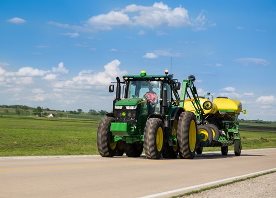 7R in transport
7R in transport

With ACS, John Deere has designed one of the most robust and full-encompassing steering system in the industry. Whether in the field or on the road, ACS reduces steering effort, which can result in reduced operator fatigue and can improve operator comfort.
There are four key features of the ACS system:
Dynamic road wheel offset
- A gyroscope senses tractor yaw and can automatically make small steering adjustments to provide unprecedented line-holding abilities. Drive down a bumpy road and experience how ACS makes it easier to keep the tractor straight, even over rough terrain. ACS delivers the ultimate in comfort.
- ACS works to prevent oversteering when a sudden obstacle causes the operator to make a quick steering reaction.
Variable ratio steering
- Approximately 3.5 turns lock to lock at in-field speeds for quick headland turns.
- Approximately 5 turns lock to lock at transport speeds.
Elimination of steering slop and hand wheel drift
- Steering wheel drift and slop are eliminated with the ACS electronic control system.
Variable effort steering
- Steering wheel resistance automatically changes with ground speed to deliver light steering effort at slower speeds for less effort during headland turns, and higher steering wheel torque at transport speeds for better operator comfort.
A fail operational system
The ACS system is fail operational, which means steering is still functional in the event of any single-point failure. John Deere has gone to great lengths to help ensure the operator can steer the tractor if something goes wrong in the steering system.
For example, if the primary controller fails, a second controller takes over. If power from the alternator is lost, the battery resumes control. If the engine quits running and is unable to supply hydraulic oil to the system, an electric-driven backup pump is used to supply the oil.
 ACS components
ACS components

The ACS system consists of several key components:
- Gyroscope: this is used to measure the yaw rate (turn rate) of the tractor during transport speeds.
- Road-wheel angle sensors: these sensors simply measure the steer angle of the tractor.
- Power supply module: this module distributes the power of the battery and alternator throughout the ACS system.
- Hand-wheel angle sensors and tactile feedback unit: this includes the steering wheel position sensors and a brake, which can increase or decrease resistance dependent on speed. Lighter feedback is desired during normal field use, and slightly heavier feedback is desired during transport and while the tractor is cornering at high speeds.
- Controllers: two controllers are located in the back of the tractor and are the brains of the system.
- Control valves: also known as steering valves, control valves are used to steer the tractor.
- Electric-drive backup pump: this pump supplies oil to the steering system, brakes, and park brakes (for towing) if there is no longer a sufficient oil supply to the steering and brakes.
Value of ACS
- Improves line holding when driving at transport speeds
- Fewer turns lock-to-lock: 3.5 turns lock-to-lock in the field for quicker headland turns and 5 turns lock-to-lock at transport speeds
- Eliminates hand-wheel backlash and drift
- Reduces steering effort, resulting in reduced operator fatigue
- Smaller hand-wheel diameter for improved operator comfort and visibility
- Maintains operator feel and touch points of traditional steering column system
- Fully integrates with AutoTrac™ guidance system
- Compatible with suspended and non-suspended front axles
- Compatible with wide- and narrow-section width tires
| Option code | Description |
| 1833 | John Deere ActiveCommand Steering (ACS) |
ActiveSeat™ seat utilizes electrohydraulic technology with air suspension
 ActiveSeat and controls
ActiveSeat and controls

John Deere’s ActiveSeat utilizes electrohydraulic technology in combination with air suspension, providing the operator with enhanced ride quality over standard air-suspension seats.
Operator movements are monitored in order to reduce vertical movement. An ActiveSeat suspension can isolate the operator from up to 90 percent of vertical movements typically seen in tractor applications.
The system uses a hydraulic cylinder that is connected to a control valve assembly. Electrohydraulic valves located in the control valve assembly automatically react to inputs from two sensors, a position sensor and an accelerometer. Inputs from these two sensors control oil flow from the tractor to the hydraulic cylinder to reduce the vertical movement of the operator.
 ActiveSeat left armrest
ActiveSeat left armrest

The John Deere ActiveSeat has many of the same features of the ComfortCommand™ seat with the addition of a ride firmness switch. The ride firmness switch is located on the left-hand armrest and replaces the suspension shock-dampening seat attenuation lever on the front right-hand side of the ComfortCommand seat controls.
The ride firmness switch has three positions: plus, minus, and mid position. The three positions provide three different levels of seat performance:
- The plus position provides the greatest degree of ride firmness. This position allows more of the tractor's inputs to be felt by the operator (slightly rougher ride).
- The minus position provides the least degree of ride firmness, allowing minimal tractor inputs to reach the operator, resulting in maximum seat performance.
- The mid position allows a balance between the plus (+) and minus (-) settings.
The ActiveSeat is also available as a heated leather seat for increased comfort and easier cleaning. For tractor applications where operating speed is not limited by the implement, the ActiveSeat can allow for faster field speeds and increased overall comfort and productivity.
NOTE: The John Deere ActiveSeat is not available on track tractors.
| Option code | Description |
| 2061 | Premium CommandView III Cab with Active Seat |
e23™ transmission
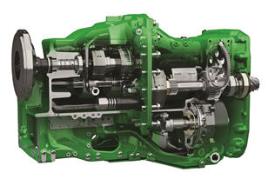 7R e23 transmission
7R e23 transmission

The e23 transmission delivers smooth shifting and intuitive controls with Efficiency Manager™ feature in a reliable 23-speed PowerShift™ transmission. The e23 transmission is available for all 7R, 8R, and 8RT Series Tractors.
The e23 has evolved from more than 50 years of John Deere PowerShift technology. With more automatic features, the e23 is easy to operate for all levels of operator experience. For more advanced operators looking to customize the transmission to best fit their operation, the e23 offers a custom mode.
As the next generation of PowerShift technology, e23 delivers the strength to handle sudden, high-torque power loads while maintaining responsive, quick, and smooth shifts. The e23 with Efficiency Manager provides improved fluid efficiency and overall productivity with limited input from the operator.
e23 options
- e23 transmission 42 km/h (26 mph) with Efficiency Manager
- e23 transmission 50 km/h (31 mph) with Efficiency Manager
Even gear spacing for optimal performance
The e23 has 23 forward gears and 11 reverse gears, which are all evenly spaced. Forward gears are spaced 15 percent apart, while reverse gears are spaced approximately 30 percent apart, providing operators smooth shifting between gears. Even spacing improves efficiency and allows for smooth, automated shifts when using Efficiency Manager. The e23 can reach maximum forward ground speed in gear F20. As a result, gears F21-F23 maintain maximum ground speed at reduced engine rpms to save fuel.
e23 controls
The e23 is available with either a right-hand or left-hand reverser.
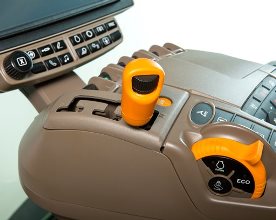 Right-hand reverser
Right-hand reverser

Right-hand reverser
A convenient, right-hand reverser is available with the e23 transmission. The reverser is located on the CommandARM™ as shown above.
- Forward direction selector
- Reverse direction selector
- Neutral position
- Electronic park lock
Right-hand reverser equipped models use three main controls to operate the tractor:
- Foot brake with integrated AutoClutch
- Set speed adjuster
- Gear selector control lever with integrated reverser
The right-hand reverser control strategy combines speed control and direction control into one multi-function lever that is conveniently located on the CommandARM. This is a good choice for most common field applications since tractor speed and direction are not constantly being adjusted by the operator.
Left-hand reverser
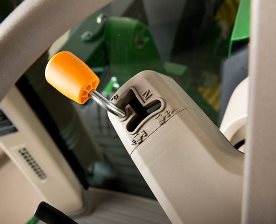 Left-hand reverser
Left-hand reverser
 Left-hand transmission lever
Left-hand transmission lever
An easy-to-use left-hand reverser is available with the e23 transmission and includes the same functions as the right-hand reverser. The reverser control is located at the 10 o’clock position on the steering column for intuitive control.
The five-position, left-hand reverser column incorporates the following controls:
- Forward direction selector
- Reverse direction selector
- Neutral position
- Electronic park lock
Left-hand reverser equipped models use four main controls to operate the tractor:
- Foot brake with integrated AutoClutch™ function
- Set speed adjuster
- Gear selector control
- Multi-function left-hand reverser
The left-hand reverser control strategy separates the direction control lever from the speed/gear control lever on the CommandARM. This strategy is a good choice for operations requiring the right hand to run multiple operations on the CommandARM or applications requiring constant directional changes like loader work.
Determining which reverser is best suited for a specific operator depends on a few key factors. Consider the following to help choose between a left- or right-hand reverser.
- Operator preference and ergonomic benefits.
- Operators in loader applications might prefer a left-hand reverser since direction changes occur frequently while their hands are on the steering wheel (near the left-hand reverser location).
Producers primarily in row-crop applications using features like AutoTrac™ assisted steering system or operating with the seat swiveled to the right for easy access to monitors and displays might find the right-hand reverser more convenient. Speed and directional controls are in one location on the CommandARM.
Foot brake with integrated AutoClutch function
The electrohydraulically controlled brakes on e23-equipped tractors have an integrated AutoClutch function.
- At low idle only, the tractor will stop by depressing only one brake pedal.
- Pressing both brakes (locked together) simultaneously will stop the tractor from any ground or engine speed.
Braking can be done on flat ground or steep slopes simply by using the brake pedals; it is not necessary to depress the clutch.
- It is recommended to lock the brake pedals together when operating on roads.
 |
| Foot brake with integrated AutoClutch |
AutoClutch sensitivity can be adjusted through the Generation 4 CommandCenter™ display. AutoClutch can be deactivated on e23 transmissions as well; however, it will be reactivated after every key start.
Custom mode
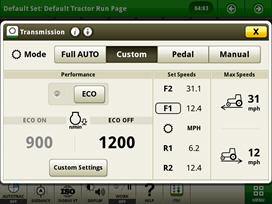 e23 custom transmission page
e23 custom transmission page

Custom mode allows operators to adjust operating parameters to meet their specific operation. Just like full AUTO mode, custom mode shifts set speeds meaning the transmission may not necessarily shift gears each time the lever is bumped. Efficiency manager is engaged automatically in custom mode.

Stopping the tractor using AutoClutch
During transport, it may be desirable to use the AutoClutch feature to stop the tractor when approaching an intersection or turn. Braking the tractor using the AutoClutch at high ground speed and engine speed will require high brake-pedal force.
Rather than using AutoClutch alone, reduce the engine rpm and reduce the e23 to a slower commanded speed before applying the AutoClutch. This will help to reduce the force needed to stop the tractor with the AutoClutch. The tractor will accelerate to the previously commanded speed upon release of the AutoClutch, repositioning of the hand throttle and increasing the commanded speed.
NOTE: The preferred method of stopping heavy towed loads is to reduce the e23 commanded speed and lower engine rpm first, and then depress both brake pedals. (Brake pedals should be locked together.)
Using individual brake pedals - implement hook-up
Individual brake pedals can be used to assist slow-speed off-road turning, such as hooking up to an implement. At low idle, the AutoClutch feature will stop the tractor if the operator depresses only one brake pedal.
To assist in hooking up an implement, depress either brake pedal while slowly increasing engine speed until the desired turn is achieved. Returning engine speed to a low idle while continuing to depress one brake pedal will slow the tractor to a stop.
CommandCenter™ controls
 254-mm (10 in.) Generation 4 CommandCenter
254-mm (10 in.) Generation 4 CommandCenter

The CommandCenter is the central information system for tractors and allows the operator to program various settings tailored to a specific operation.
To access the tractor’s transmission settings, press the transmission shortcut button on the CommandCenter shortcut bar.
 |
| CommandCenter transmission shortcut button |
Operating modes
The e23 application settings employ three modes to take full advantage of the engine-transmission communication: full auto mode, custom mode, and manual mode.
Full auto mode
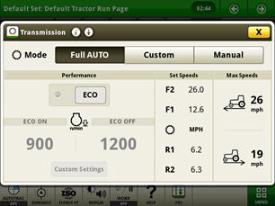 Full auto main page
Full auto main page

Full AUTO mode enables the tractor to make adjustments to the transmission operating mode automatically, based on engine and transmission speed and the load on the tractor. This means the tractor will shift up and throttle back automatically to reach the desired ground speed efficiently. Operators have the ability to set the maximum forward and reverse speeds for the tractor in their particular application.
When shifting in full AUTO mode, the transmission shifts set speeds, meaning the transmission may not necessarily shift gears each time the lever is bumped. Efficiency Manager is automatically engaged while operating in full AUTO mode. As a result, shifting will not take the tractor out of Efficiency Manager in full AUTO mode.
Advanced transmission settings
Additional transmission settings can be customized to the operators’ specific desires.
AutoClutch sensitivity can be adjusted on the transmission settings page in the CommandCenter display. Operators can turn off AutoClutch or choose from high, medium, or low sensitivity. Operators can fine-tune AutoClutch by delaying the response time, based on load, travel speed, etcetera. This allows the trailer brakes to be applied before AutoClutch engages.
- High: for light or no trailer (load) – factory default
- Medium: for medium trailers (load)
- Low: for heavy trailers (load)
- AutoClutch Off: to operate e23 just like a traditional powershift
The AutoClutch sensitivity factory default-setting is set to high, which supports most operations.
AutoClutch sensitivity settings are available in all three modes – auto, custom, and manual.
Efficiency manager
 |
| Set speed buttons and set speed adjuster |
Efficiency manager is automatically enabled in full AUTO and custom mode. Efficiency manager can be turned on in manual mode by selecting the set speed one or two on the CommandARM. The set speed adjuster on the top of the single-lever gear selector allows the operator to dial in the desired ground speed to establish set speed one or two in Efficiency Manager.
Efficiency manager allows the transmission to up or down shift and change engine rpm to maintain the set wheel speed. To reach the desired set speed, the throttle must be set to full engine rpm. This allows efficiency manager to shift the transmission and adjust engine speed to maintain the desired wheel speed. For more information on Efficiency Manager refer to the operator’s manual.
e23 operation
Both right-hand reverser and left-hand reverser control options provide full powershifts for on-the-go shifting; no need to stop or clutch when bump shifting or shuttle shifting between forward and reverse.
The single-lever shifter allows for quick and convenient shifting with minimal physical effort.
Shifts are made either by bumping the lever or by holding the lever in a forward or rearward position.
- Transmission is in neutral when the shift control or left-hand reverser is not in park, forward, or reverse.
- Operator presence feature prevents the transmission from going into gear when the operator is not seated or has the brake or clutch pedal depressed.
- Transmission can be programmed to start in 1F – 13F or 1R – 6R.
A forward gear between 1F and 13F may be preselected by depressing the clutch pedal and pushing or pulling the shift lever. The transmission will then start in the preselected forward gear when clutch pedal is released.
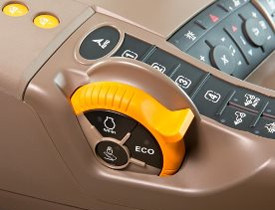 Eco button
Eco button
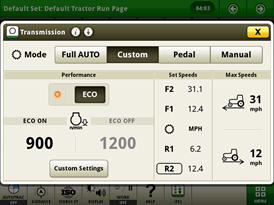 Display screen
Display screen
In custom mode, eco allows two minimum engine speeds to be set. Operators can turn eco on and off by either pushing the eco button on the side of the throttle or by selecting eco in the transmission settings page of the CommandCenter. For example, operators may choose to turn eco on during transport to utilize a lower minimum engine speed and then turn eco off while operating in the field where a higher minimum engine speed is desired.
 Custom settings page
Custom settings page

In the advanced settings page, operators can customize the auto shift engine speed droop as a percentage of the full engine speed. In addition, the load anticipation feature can be enabled for the hitch engagement, hydraulic engagement, or both.
Manual mode
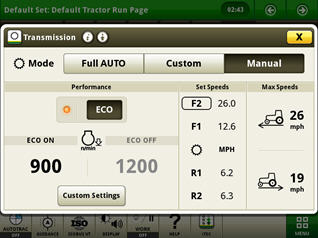 Manual mode page
Manual mode page

Manual mode operates similar to a traditional PowerShift transmission. When shifting, the transmission shifts gears, not set speeds like full AUTO and custom mode. Manual mode also features efficiency manager when the operator engages set speed one or two on the CommandARM, as shown above in illustration.
When operating in manual mode with efficiency manager active, there is the option of turning eco on or eco off. This allows the operator to select two different minimum engine speeds. In the advanced settings page, operators can adjust auto shift engine speed droop and load anticipation, similar to custom mode.
 Cornerpost display
Cornerpost display

The cornerpost display shows the commanded gear instantaneously once selected.
| Option code | Description |
| 1493 | e23 Transmission 42 km/h (26 mph) with Efficiency Manager |
| 1494 | e23 Transmission 50 km/h (31 mph) with Efficiency Manager |
| 2701 | Right-hand Reverser Bump-Shift-Type Transmission Controls |
| 2702 | Left-hand Reverser Bump-Shift-Type Transmission Controls |
Rapid shifting
 Rapid shifting
Rapid shifting

When the tractor is working in a light-load condition, for example in transport, the transmission can be shifted rapidly by bumping the shift lever.
To reach transport speeds quickly:
- Depress clutch pedal and rapidly bump shift lever to 13F
- Transmission will shift directly to 13F when clutch pedal is released
- Transmission will skip some gears as it keeps up with the operator’s command, allowing the tractor to accelerate to transport speed quickly
- Once tractor is underway in 13F, bump the shift lever to reach desired ground speed
Double shifting
The transmission can skip a gear when operating under load by double bumping the shift lever.
- This aids the ease of deceleration/acceleration when approaching and departing headland turns.
Ground speed matching
When the tractor is slowing down and the clutch pedal is depressed, the transmission will match a gear to the ground speed of the tractor when the clutch is released. Ground speed matching only engages in gears 13F higher.
Setting start-up gears
The transmission defaults to 8F and 3R at start-up. However, these default start-up gears can be adjusted from 1-13F and 1-6R through the CommandCenter. Refer to the operator’s manual for additional information.
 |
| Start-up gears in advanced settings |
Releasing the park brake
The e23 transmission utilizes a spring-engaged/hydraulically-disengaged park brake. The park brake control feature prevents accidental park brake engagement when tractor is moving at high speed.
On tractors equipped with air brakes, the park brake automatically activates the air brake system.
Standard CommandView™ III cab offers unsurpassed amenities
 CommandView III cab
CommandView III cab
The Standard CommandView III cab offers unsurpassed visibility, operator comfort, control placement, and ride and sound quality.
Features:
- ComfortCommand™ seat with air suspension, lumbar support, swivel, fore-aft and lateral attenuation, backrest angle adjustment, adjustable left-hand armrest, and 40-degree right-hand seat swivel
- Operator presence system that warns if the operator is out of the seat while operating key functions
- Folding instructional seat
- CommandARM™ console with integrated controls
- 4100 or 4600 Generation 4 CommandCenter™ display
- Behind-the-seat storage
- Left-hand storage compartment
- Passive noise reduction system
- Service ADVISOR™ data port
- Tilt/telescoping steering wheel with position memory
- Swing-out rear window that opens 30 degrees
- Right- and left-outside mirrors (manually adjustable mirror head)
- Monitor mounts on right-hand front post and rear cab post
- Standard radio package, including AM/FM stereo and weatherband with remote controls, auxiliary input jack, four speakers, and an external antenna
- Laminated glass
- Air conditioner and heater with automatic temperature controls (ATC)
- Two 12-V convenience outlet (cigarette lighter style)
- One 12-V three-pin outlet with adapter (provides switched and unswitched power)
- One International Organization for Standardization (ISO) nine-pin connector
- Power strip with convenience plug adapter
- Hitch control lever lock and selective control lever lock
- Two-speed and intermittent front and rear wiper with washer
- Front pull-down sunshade
- Digital cornerpost display with:
- Fuel level gauge, including low fuel warning
- Temperature gauge
- Diesel exhaust fluid (DEF) gauge, including low DEF warning
- Engine rpm
- Transmission commanded gear or speed
- Vehicle system functions, such as iTEC™ system, that are operating
- Inside-mounted rearview mirror
- Beverage holders sized to accommodate various containers
- Interior left-hand dome light
ComfortCommand seat
 ComfortCommand seat
ComfortCommand seat
ComfortCommand seat improves ride quality and helps to reduce operator fatigue.
Features include:
- Armrests, lumbar support, and backrest angle are easily adjusted to match operator preference.
- Shock absorbers dampen the motion effect of the tractor for an improved ride.
- Seat height adjustments are conveniently located on the left armrest.
- Fore-aft adjustment is easy to reach located on the left front of the seat.
- Swivel adjustment, located on the front of the seat, allows the seat to be swiveled 40 degrees to the right or eight degrees to the left of the center position.
- Operator presence switch warns if the operator is out of the seat while operating key functions.
- Seat belt retractor.
- Centered cab seat provides excellent over-shoulder visibility.
- Adjustable shock absorber permits ride adjustment from soft to firm to match the operator's desired comfort level.
- Removable cushions allow for easy cleaning.
 Fingertip paddle pots
Fingertip paddle pots
 Encoder wheel
Encoder wheel
CommandARM
 CommandARM controls
CommandARM controls
John Deere 7R and 8R Series Tractors feature the CommandARM with integrated Generation 4 CommandCenter display. The control layout of the CommandARM utilizes a clean and efficient design which groups controls by function and builds upon John Deere’s history of intuitive and ergonomic control placement and operation. The design of the CommandARM allows for a 40 degree right seat swivel and adjustable positioning matching the operator’s preference.
Controls located on the CommandARM include:
- Engine throttle
- FieldCruise™ system
- Minimum engine speed – CommandQuad™ transmission, 16-speed PowerShift™ transmission (PST), e23™ transmission
- Eco mode – Infinitely Variable Transmission (IVT™)
- Foot pedal lock (if equipped)
- Transmission control
- Hitch/selective control valve (SCV) controls
- Rotary encoder hitch control
- Power take-off (PTO) controls
- Mechanical front-wheel drive (MFWD) on/automatic
- Differential lock on/automatic
- iTEC sequence switches
- AutoTrac™ assisted steering system resume switch (if equipped)
- Joystick (if equipped)
- Radio
- Beacon light on/off
- Hazard lights on/off
- Field lights 1/2
- Heating, ventilation, air conditioning (HVAC) system
Transmission controls
John Deere 7R Series Tractors with CommandQuad transmissions feature a left-hand reverser. 8R Series Tractors equipped with 16-speed PST are equipped with right-hand reverser. 7R Series Tractors equipped with e23 PST offer a left- or right-hand reverser. 7R or 8R Series Tractors equipped with AutoPowr™/IVT transmissions are offered with either a left-hand or a right-hand reverser.
The transmission control lever is placed on the left side of the CommandARM closest to the operator for convenient setting and adjustment.
 Left-hand CommandQuad/e23 reverser
Left-hand CommandQuad/e23 reverser
 Right-hand IVT and PST reverser
Right-hand IVT and PST reverser
 16-speed PST right-hand reverser
16-speed PST right-hand reverser
Hydraulic and hitch controls
Hydraulic and hitch controls utilize fingertip paddle pots for raise/lower and extend/retract functions. An optional crossgate joystick replaces fingertip paddle pots for control of SCVs and allows for programmable hydraulic functionality according to operator preference. Rear hitch position can also be controlled with the encoder wheel located on the right side of the CommandARM. The encoder wheel allows for finite positioning of the rear 3-point hitch.
Three buttons near the encoder are for hitch set, lock, and return to height. Adjustment knobs for the 3-point hitch are located under the cover for the CommandARM control's storage compartment and allow for adjustment of the rate of drop, hitch height limit, and depth control.
 Hitch controls
Hitch controls
 Optional crossgate joystick
Optional crossgate joystick
Throttle
The throttle design incorporates buttons which control FieldCruise speed, foot pedal mode (if equipped), and transmission eco settings.
 Throttle
Throttle
 Foot throttle
Foot throttle
Tractor function controls
Located just to the right of the throttle is the AutoTrac activation button and four sequence controls for iTEC functions. Behind the iTEC sequence controls, there are buttons which control the activation and deactivation of MFWD and differential lock.
 AutoTrac resume and iTEC strip
AutoTrac resume and iTEC strip
Controls for radio, lights, rotary beacon (if equipped), hazard flashers, and HVAC system are located to the center-right on the CommandARM, along with PTO for both front (if equipped) and rear PTO.
 Radio, HVAC, hazard flashers, and PTO controls
Radio, HVAC, hazard flashers, and PTO controls
Seat swivel
The design of the CommandARM allows for up to 40 degrees of right-hand seat swivel.
 Seat swivel
Seat swivel
CommandCenter
 Generation 4 CommandCenter
Generation 4 CommandCenter
The Generation 4 CommandCenter features fast adjustment of tractor functions and controls and are integrated into the CommandARM to create a seamless control center. The 4100 CommandCenter features a 178-mm (7-in.) touchscreen display and is standard equipment on 7210R and 7230R models, while the 4600 CommandCenter features a 154-mm (10-in.) touchscreen and is standard equipment on 7250R – 7310R models, as well as all 8R and 8RT models.
The following functions can be adjusted using the CommandCenter display:
- Hydraulic settings
- Hitch settings
- Transmission settings
- FieldCruise
- iTEC programming functions
- Radio
- Lights
The 7R Series cooling system
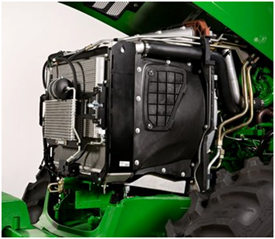 7R Series cooling package
7R Series cooling package
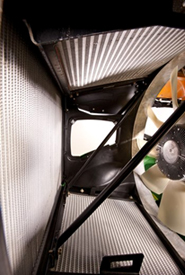 Pull-style fan and radiator access
Pull-style fan and radiator access
The 7R Series Tractors feature an increased front area (IFA) cooling system that utilizes a pull-style fan that improves cooling efficiency over an increased surface area that provides better cooling capacity and reduces fan noise during increased power levels or while under heavy loads.
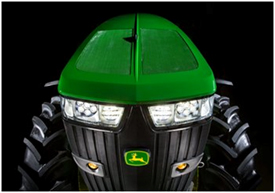 Hood screen area
Hood screen area
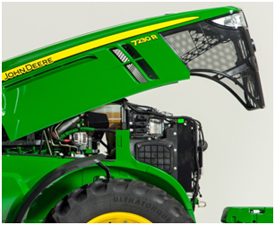 Engine hood with side shields
Engine hood with side shields
The 7R Series Tractors also have an increased screen area on the hood and redesigned side shields to help reduce debris buildup. The new cooling system provides easy, cooler cleanout and service accessibility without sacrifice to turning radius or front hitch and front power take-off (PTO) applications.
Front hitch options fit a variety of applications
 7R Series Tractor with front hitch
7R Series Tractor with front hitch
The 7R Series Tractors offer two front hitch options to best fit a variety of applications.
Standard (non-ground-engaging) hitch option for applications including, but not limited to:
- Front-mounted mowers, toppers, and snow blowers
- Carrying front seed hoppers and plow packers
- Carrying front ballast
- Operating light-draft implements
Premium (ground-engaging) hitch option for applications including, but not limited to:
- Operating primary tillage equipment and standard blades
Premium hitches include a push bar and heavier lift arms:
- Hitches with zero front auxiliary valves include one mid-mount valve.
- Hitches with one front auxiliary valve include two mid-mount valves.
- Hitches with two front auxiliary valves include three mid-mount valves.
To ensure adequate hydraulic availability, up to two selective control valves (SCVs) can be included with a front hitch.
 Joystick control
Joystick control
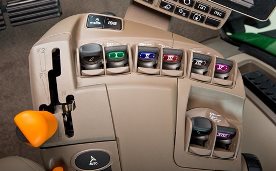 Paddle pot SCV
Paddle pot SCV
Tractors equipped with a factory front hitch have the option of selecting a joystick control or paddle pot SCV controls. The joystick control is not compatible with the sixth rear electrohydraulic SCV because of the CommandARM™ controls space required for the front hitch joystick.
Features of John Deere factory-installed front hitches include:
|
Standard |
Premium |
Lift capacity at ball ends (ISO) |
5200 kg (11,464 lb) |
5200 kg (11,464 lb) |
Lift range |
750 mm (29.5 in.) |
750 mm (29.5 in.) |
Overhang when folded |
55 mm (2.2 in.) |
55 mm (2.2 in.) |
Approach angle (depending on tire and axle setup) |
25.5 - 38.7 degrees |
25.5 - 38.7 degrees |
Reinforcing push bar |
Field-installed option |
Standard |
Auxiliary valve with front couplers |
Optional |
Standard |
Category 3N hitch |
Standard |
Standard |
7-pin connector - for implement lights |
Standard |
Standard |
9-pin harness and connector (ISO) |
Field-installed option |
Field-installed option |
Front-mounted remote switch |
Standard |
Standard |
Hitch damping |
Triple-Link Suspension (TLS™) axle, same effect |
TLS axle, same effect |
Hydraulic mode select |
Single and dual |
Single and dual |
Electronic position control |
Yes |
Yes |
Full ground clearance |
Yes |
Yes* |
iTEC™ compatible |
Yes |
Yes |
Power take-off (PTO) compatible |
Yes |
Yes |
Installed weight (with push bar)** |
-- |
455 kg (1003 lb) |
Installed weight (no push bar)** |
345 kg (760 lb) |
-- |
*Hitches with a push bar maintain front axle to ground clearance for row-crop applications and can be used with ground-engaging implements, including primary tillage implements and standard blades.
**Equals weight of added hitch components.
The integrated and styled compact hitch design maintains full maneuverability even with the larger front tires. The hitch extends only 55-mm (2.2-in.) ahead of the front support when the arms are folded.
Standard (carrier version) hitches can be converted to a premium (ground-engaging) hitch by ordering and field installing a conversion kit that includes push bar and heavier lift arms.
All factory-installed front hitches are capable of single- and dual-acting hydraulic cylinder modes. This allows the operator the flexibility to choose the correct mode for a variety of front hitch applications. Single acting provides hydraulic force for retracting the front hitch cylinders and allows front implements to follow the contour of the ground or surface. For example, this would be the correct mode for a front-mounted snow blower. Dual acting provides hydraulic force in retracting and extending the front hitch cylinders to provide down force for ground-engaging implements.
Additional hitch features include:
- Integrated and protected routing of oil lines
- Category 3 top link with storage position
- Integrated towing clevis with pin
- Compatible with group 42 - 44 front tires
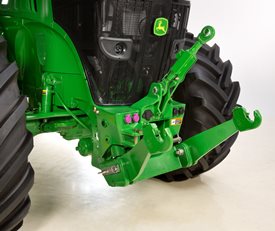 7R position sensing
7R position sensing
The 7R with front hitch comes equipped with position sensing that allows operators the ability to establish an upper height limit set point and lower limit set point through CommandCenter™ display. Position sensing maintains the height of the hitch arms based on the set points.
Position sensing provides the following benefits:
- Add to iTEC™ display sequence (raise/lower set points)
- Limit height for front-PTO implement (stay within desirable driveline angles)
- Set lower position for ground-engaging depth or blade position
- Maintain set height without added fixed link (position will auto correct)
- Prevent inadvertent hitch operation outside of desired range of motion (takes guesswork out of placing height of front implement)
- Less fatiguing for repetitive-type work where the same position is required over and over
For a 9-pin connector, order kit RE322555. The kit includes all necessary components and allows ISO implement communication.
NOTE: 7R Series Tractors with a factory-installed front hitch do not ship with a front weight support.
Front hitch – Field-installed options:
For more information on ordering a front hitch ready configuration, refer to Attachments, front hitch/power take-off (PTO) ready
For tractors ordered non-hitch or non-hitch ready please contact LaForge® company for front hitch options.
Laforge Systems Inc.
4425-C Treat Blvd. #230
Concord, California 94521
Phone: (925) 827-2010 or 1-800-422-5636
Web site: www.fronthitch.com
LaForge is a trademark of Laforge Corporation.
Front hitch options:
- Standard front hitch with zero front couplers, 5200-kg (11,450-lb) maximum lift capacity at hitch balls
- NOTE: 3150-kg (6944-lb) International Organization for Standardization (ISO) lift capacity.
Less push bar (hitch raise/lower hard plumbed to mid-mount valve)
Includes zero front auxiliary couplers.
ISOBUS connector available through Parts.
- NOTE: 3150-kg (6944-lb) International Organization for Standardization (ISO) lift capacity.
- Standard front hitch with one front auxiliary coupler, 5200-kg (11,450-lb) maximum lift capacity at hitch balls
- NOTE: 3150-kg (6944-lb-) ISO lift capacity.
Less push bar (hitch raise/lower hard plumbed to mid-mount valve)
Includes one front auxiliary couplers.
ISOBUS connector available through Parts.
- NOTE: 3150-kg (6944-lb-) ISO lift capacity.
- Premium front hitch with one front auxiliary coupler, 5200-kg (11,450-lb) maximum lift capacity at hitch balls
- NOTE: 3150-kg (6944-lb) ISO lift capacity.
Includes push bar (hitch raise/lower hard plumbed to mid-mount valve)
Includes one front auxiliary couplers.
ISOBUS connector available through Parts.
- NOTE: 3150-kg (6944-lb) ISO lift capacity.
- Standard front hitch with two front auxiliary couplers, 5200-kg (11,450-lb) maximum lift capacity at hitch balls
- NOTE: 3150-kg (6944-lb) ISO lift capacity.
Less push bar (hitch raise/lower hard plumbed to mid-mount valve)
Includes two front auxiliary couplers.
ISOBUS connector available through Parts.
- NOTE: 3150-kg (6944-lb) ISO lift capacity.
- Premium front hitch with two front auxiliary coupler, 5200-kg (11,450-lb) maximum lift capacity at hitch balls
- NOTE: 3150-kg (6944-lb) ISO lift capacity.
Includes push bar (hitch raise/lower hard plumbed to mid-mount valve).
Includes two front auxiliary couplers.
ISOBUS connector available through Parts.
- NOTE: 3150-kg (6944-lb) ISO lift capacity.
- CommandARM™ paddle pot SCV controls
- NOTE: Not compatible with joystick control.
Provides proportional paddle pot SCV control for mid-mount valve(s).
- NOTE: Not compatible with joystick control.
- Joystick control
- NOTE: Does not include mid-mount valve or loader-ready components.
ISOBUS compatible.
Not compatible with six rear SCVs.
Not compatible with CommandARM SCV controls.
- NOTE: Does not include mid-mount valve or loader-ready components.
Triple-Link Suspension Plus (TLS™ Plus)
 7R with TLS Plus
7R with TLS Plus

The optional TLS Plus is a fully integrated, self-leveling front suspension system available on 7R Series Tractors equipped with the 1300 mechanical front-wheel drive (MFWD) axle. TLS Plus provides exclusive front suspension using a hydro-pneumatic self-leveling system to increase productivity and improve ride dramatically. TLS Plus provides more control over the front suspension of the tractor.
 CommandCenter screen
CommandCenter screen

In the Generation 4 CommandCenter™, the operator is able to select maximum pressure to accommodate for the transfer of heavy loads with minimal front axle movement.
TLS Plus increases both transport and field productivity with superior stability, ride, and comfort. Loader operators appreciate the enhanced performance when transporting bales or a full bucket of silage. In the field, the TLS Plus front suspension maintains ground-to-tire contact, enabling more power to the ground.
The TLS Plus front axle is available with or without wet-disc front brakes. While TLS Plus is available on all 7R Series Large-Frame Tractors, it is a requirement for the following:
31-mph/50K CommandQuad™ Eco
31–mph/50K e23™
31–mph/50K infinitely variable transmission (IVT™)
TLS Plus components
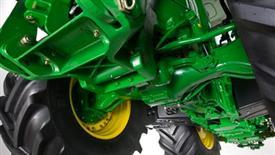 7R with TLS Plus
7R with TLS Plus
Two double-acting-control cylinders act independently or together to dampen shock loads, while supplying a constant down force on the axle for better traction. In addition to the cylinders, a pan-hard rod limits lateral motion while an electronic sensor signals a priority valve to automatically move the control cylinders as needed.
The cast driveline draft member controls fore-aft suspension of the axle. This heavy-duty conical casting encloses the entire driveline and transfers longitudinal forces to the tractor's center of gravity.
 1300 axle with TLS Plus
1300 axle with TLS Plus
 1300 axle cutaway with TLS Plus
1300 axle cutaway with TLS Plus
Operating characteristics:
- TLS Plus self-levels at engine start-up with the implement attached and the hitch in the raised or lowered position.
- TLS Plus self-levels whenever the tractor speed exceeds 0.9 mph (1.5 km/h).
 Automatic differential lock angle adjustment
Automatic differential lock angle adjustment
Differential lock
 CommandARM™ controls with automatic differential lock engaged
CommandARM™ controls with automatic differential lock engaged
 CommandARM controls with manual differential lock engaged
CommandARM controls with manual differential lock engaged
The differential lock is another feature of the 1300 Series MFWD axle with Triple-Link Suspension (TLS) PLUS, driveline shield, hydraulic on/off differential lock, and wet-disk front brakes. When the rear differential lock is engaged or disengaged, the front differential lock is also engaged or disengaged. This also includes a driveline shield.
If one wheel begins to slip, the differential lock can be engaged on the go and the axles are hydraulically locked together for maximum traction. There are two ways to engage the differential lock feature.
- Manual differential lock - differential lock can be engaged manually using a switch on the floor or by manual depressing button on CommandARM. When brakes are depressed, the differential lock will disengage
- Automatic Differential lock - when in auto mode, differential lock is engaged when the tractor is driving forward. Differential lock will disengage when front wheel turn angle meets disengage wheel angle setting defined by the operator via the CommandCenter or when either brake pedal is depressed. Differential lock will automatically engage when brakes are released or front wheels are turned straight.
Take advantage of the Generation 4 CommandCenter™ display, designed for efficiency
The Generation 4 CommandCenter was designed to provide a consistent user experience by providing full-screen viewing of more run page modules, shortcut keys, and precision agriculture capabilities.
Expect easier set-up, along with increased operator confidence, thanks to a simple, customizable interface. The improved design of the Generation 4 CommandCenter also aids in an optimal operating experience and maximizes uptime.
In order to increase your efficiency, take advantage of the following features offered by the Generation 4 CommandCenter:
Layout manager
 Layout manager selection page
Layout manager selection page
 Layout manager module build
Layout manager module build
- Easily create page views that meet your needs and that are also equipped with default run pages.
- Users and access allow the owner or manager to lock out certain functions to prevent operators from accessing or changing settings with a defined four-digit code.
- Gather on-screen help by selecting the help icon on the shortcut bar on the bottom of every page.
Machine monitor
 Machine monitor page
Machine monitor page
- The Machine Monitor application provides you instantaneous readings about the status or condition of your machine.
- This application shows parameters such as engine speed, coolant temperature, and ground speed.
Work monitor
 Work monitor page
Work monitor page
- The Work Monitor application displays performance information about the task being performed by the machine.
- You are shown averages, totals, and productivity of the machine, such as area worked, average working speed, and fuel usage.
- Work setup places the settings needed to properly setup features such as AutoTrac, Documentation, and Section Control in a single location. Settings include:
- Client, farm, and field
- Crop type
- Machine and implement dimensions
- Variety/hybrid and planting/seeding rates
- Variable rate prescriptions
- Product and application rates
- Application rates through the implement screens
Video capability
- Machines equipped with a 4200 CommandCenter are equipped with one video input, and the 4600 CommandCenter has four video inputs.
- You have the ability to set a variety of triggers. With each trigger, the image will then appear on the display.
Flags
 Create flags to mark items in the field
Create flags to mark items in the field
- Mark areas in the field that need special attention such as rocks, tile lines, or weed pressure.
- Flags previously recorded on the Gen 4 or GreenStar™ 3 2630 Display can be transferred between monitors.
- Flags previously recorded on the Gen 4 or GreenStar™ 3 2630 Display can be transferred between monitors.
Field boundaries
 Boundary creation from coverage
Boundary creation from coverage
 Headland creation
Headland creation
- Manually drive field boundaries with the Generation 4 CommandCenter or import existing boundary information from the GreenStar 3 2630 Display or John Deere Operations Center. Gen 4 documentation data can be used to create boundaries from coverage within the John Deere Operations Center.
Dual-display mode
 Dual display
Dual display
- Generation 4 CommandCenter may be configured to run with the following John Deere displays connected at the cornerpost of a John Deere tractor:
- GreenStar 2 1800 Display
- GreenStar 2 2600 Display
- GreenStar 3 2630 Display
- 4640 Universal Display
- 4240 Universal Display
NOTE: Vehicle applications will always be located on the Gen 4 CommandCenter.
Automatic base station switching
 Setup base stations in Fields and Boundaries applications
Setup base stations in Fields and Boundaries applications
- Customers using John Deere RTK Radio 450 or 900 can link a base station to a desired client,/ farm,/ or field. This allows automatic switching to the associated base station when changing fields. The ability to import base station assignments into Operations Center and send back to machines will be available at a later date.
Video looping supported with Gen 4 4600 CommandCenter Display and 4640 Universal Display
 Scan through videos with video looping
Scan through videos with video looping
- This feature enables users to scan or loop through all of the available video feeds for a specified duration. The default scan time is set to 7 seconds per image. The scan time is customizable per image allowing for consistent visibility to all video feeds.
ISOBUS and tractor-baler automation offer new baling experience
Tractor-Baler Automation simplifies baling experience
 A single manual action; system manages the rest
A single manual action; system manages the rest
 TBA awards
TBA awards
The optional Tractor-Baler Automation (TBA) makes baling easy. This exclusive system manages most of the baling process and gives the customer the following advantages:
- High baling comfort a single action to bale instead of four.
- Error proof baling - even after 10 working hours, the system does not forget any action; a true advantage for an inexperienced driver.
- Constant bale quality - same diameter bale after bale
- Constant productivity - no reduced efficiency due to operators fatigue.
When used with a John Deere ISOBUS tractor, electric selective control valve (E-SCV), and (IVT™) transmission, the system will be able to:
- Stop the tractor when bale size is reached
- Wrap the bale
- Open the gate
- Close the gate when bale is unloaded
The only action remaining is to forward reverser and manage the steering.
If the John Deere tractor is not equipped with IVT but has E-SCV and ISOBUS, opening and closing can be automated.
A single touch on SCV, brakes, or reverser will disengage the automation. In the same way, automated open/close can be momentarily stopped when unloading in hilly conditions.
Tractor-Implement Automation is an exclusive green on green advantage. This advanced technology option has won awards at SIMA and Agritechnica farm equipment show in Europe, a true cost/value guarantee.
NOTE: to run through fully automated mode, a John Deere Isobus tractor with E-SCV and IVT is required. A baler activation key and a tractor activation key (different) have to be ordered.
ISOBUS certified balers
 Plug in and bale with ISOBUS
Plug in and bale with ISOBUS
 ISOBUS certified = compatibility guarantee
ISOBUS certified = compatibility guarantee
The 990 and 960 Balers offer ISOBUS compatibility as base equipment. This standardized communication not only allows the use of John Deere Greenstar2 1800, 2600, or 2630 Displays, but also the use of other ISOBUS conform competitive monitors.
Adapter harnesses for non-ISOBUS tractors are available.
User friendly interface
 Main page with simple and clear pictograms
Main page with simple and clear pictograms
 Bale or soft core density adjustments
Bale or soft core density adjustments
The Baler interface displays information that is needed. The 900 Series monitors provide all required information:
- Bale shape and diameter
- Drop floor and knives position
- Variable core activation
- Tying process status
- Gate position
- Maintenance status
Adjustments can also be managed from the operators station:
- Bale size and density
- Variable core diameter and density
- Net and twine tying parameters
- Knife selection
- Automated lubrication
- Tractor-Baler Automation status
- Bale counter resets
Greenstar™2 1800 has the ideal display for baling application
 Greenstar2 1800 Display ordered with the baler
Greenstar2 1800 Display ordered with the baler

The 900 Series Balers can be teamed with all ISOBUS certified displays. The Greenstar2 1800 monitor can be ordered with the baler to match traditional baling requirements. When not baling this display can be used for other functions such as guidance and spraying applications when connected to an appropriate receiver and implement.
All ISOBUS display will fit the 900 Series
 GreenStar3 2630 fits the most demanding user needs
GreenStar3 2630 fits the most demanding user needs

The 960 and 990 Balers can be ordered without a monitor for customers who already have an ISOBUS display, or for those who search more advanced application (field management). Displays other than John Deere Greenstar2 1800 can be purchased through Ag Management Solutions (AMS) pages.
Features
Lighting packages provide 360 degrees of coverage for maximum productivity
 Premium lights
Premium lights

The 7R, 8R, and 8RT Series Tractors feature two lighting package options:
- Standard
- Premium
The cab lighting pattern provides 330 degrees of coverage while the hood lighting provides the remaining 30 degrees for completely programmable 360-degree, stadium-style lighting. This ensures there are no dead zones or lighting adjustments needed. The lighting configurations are available to match various applications and ensure maximum around-the-clock productivity.
Bulb housings are large, allowing for optimum total lumens and available light. The standard lighting packages use 65-W halogen bulbs, whereas the premium lighting package uses light-emitting diode (LED) lights. In the premium lighting package, these tractors take advantage of the high-performing and efficient LED technology.
The low- and high-beam driving/work lights are adjustable. Please refer to the electrical section in the operator’s manual for complete details on adjusting lights.
 7R/8R/8RT lighting
7R/8R/8RT lighting

Yellow circles
- All lighting packages: 65-W halogen: road low beam
Red circles
- Standard: 65-W halogen
- Premium: LED
Blue circles
- Standard: 65-W halogen; field and road high beams
- Premium: LED
Orange circles
- Standard: blank
- Premium: LED
|
Standard lighting
 Standard lighting (8R)
Standard lighting (8R)
 Standard lighting (7R)
Standard lighting (7R)
Six front grill-mounted lights:
- Two 65-W low-beam driving/work lights (mid grill screen)
- Two 65-W high-beam driving/work lights (top of grill screen, hood mounted)
- Two front corner-facing halogen work lights (top of grill screen, hood mounted)
10 cab roof-mounted lights:
- Two rear-facing 65-W floodlights
- Four side-facing 65-W floodlights
- Four corner-facing amber lights
Other lights:
- Two rear fender-mounted floodlights
- Two rear turn signal and brake/tail lights (fender mounted)
- Two folding-extremity lights
Plus these lights:
- Two adjustable front roof 65-W halogen floodlights
- Two front belt-line floodlights
- Rotary beacon light
Premium lighting
Eight front grill-mounted lights:
- Two 65-W low-beam halogen driving/work lights (mid grill screen)
- Two LED high-beam driving/work lights (top of grill screen, hood mounted)
- Two front corner-facing LED work lights (top of grill screen, hood mounted)
- Two front-facing LED working lights (top of grill screen, hood mounted, inner position on the sides)
12 cab roof-mounted lights:
- Four side-facing LED lights
- Four corner-facing amber lights
- Two rear-facing LED lights
- Two adjustable front roof LED lights
Other lights:
- Two rear fender-mounted LED lights
- Two rear turn signal and brake lights (fender mounted)
- Two folding-extremity lights
- Two front belt-line LED floodlights
- Rotary beacon light
The premium lighting package replaces all previous halogen and HID lights with LED lights. The only lights that are not LED are the low-beam driving lights, they remain halogen. This allows each LED light to work at a lower temperature and no one light works harder than any other. The uniformity in LED coverage allows only one type of light output surrounding the tractor.
The lighting pattern in the premium package provides industry-leading performance in nighttime visibility. LED bulbs provide maximum brightness and a true color output for excellent field definition that is easy on the operator's eyes.
The LED lights provide 40 percent greater coverage width and 10 percent more light coverage in the rear. LED lighting packages use 45 percent less amps than standard halogen lights and have an increased life expectancy over HID lights which leads to lower costs of ownership over the life of the tractor.
NOTE: Lighting packages may vary depending on region.
Selecting a lighting mode/programmable lighting
 Lighting mode selector
Lighting mode selector

Operators can quickly select a lighting mode on the steering console:
- Lights, off position
- Road lights
- Field lights
 The CommandCenter™ display
The CommandCenter™ display
The CommandCenter display allows operators to customize light settings. Operators can select only the lights they need or want for a given application and store these settings. The operator-programmed configurations can then be turned on or off with the push of a button on the CommandARM™ controls.
- Programmable field lights 1
- Programmable field lights 2
- Beacon light
- Emergency flashers
NOTE: Road/loader lights are also referred to as high-mounted driving lights for use in front hitch applications that obscure the headlights. See the Attachments section.
The battery power saver feature is also standard. When the engine is off and the outside lights have been left on, this feature is designed to avoid battery run down.
After the lights have been left on for 30 minutes and the key is in the off position, the lights cycle or blink on and off five times as an alert. The lights continue to illuminate for one more minute and then automatically shut off to protect the battery.
Programmable exit lighting
Another feature is programmable exit lighting. Exit lighting allows the lights outside the cab to stay on for up to 300 seconds. They can be programmed in increments from 0 to 300 seconds.
Refer to the operator’s manual for complete instructions on programming field, driving, and exit lighting.
Field-installed options
Field-installed options are also available. To find this information, use the Build Your own Configurator application for US/Canada or Build & Price in John Deere Sales Centre for Australia/NZ.
| Option code | Description |
| 7201 | Standard lighting |
| 7206 | Premium lighting |
Steering
The steering system uses load sensing of hydraulic pressure required to efficiently complete the designated tasks. The pressure- and flow- compensating pump produces excellent stationary or creeping ground speed steering response to handle demanding applications.
ActiveCommand Steering (ACS™)
 7R in transport
7R in transport

With ACS, John Deere has designed one of the most robust and full-encompassing steering system in the industry. Whether in the field or on the road, ACS reduces steering effort, which can result in reduced operator fatigue and can improve operator comfort.
There are four key features of the ACS system:
Dynamic road wheel offset
- A gyroscope senses tractor yaw and can automatically make small steering adjustments to provide unprecedented line-holding abilities. Drive down a bumpy road and experience how ACS makes it easier to keep the tractor straight, even over rough terrain. ACS delivers the ultimate in comfort.
- ACS works to prevent oversteering when a sudden obstacle causes the operator to make a quick steering reaction.
Variable ratio steering
- Approximately 3.5 turns lock to lock at in-field speeds for quick headland turns.
- Approximately 5 turns lock to lock at transport speeds.
Elimination of steering slop and hand wheel drift
- Steering wheel drift and slop are eliminated with the ACS electronic control system.
Variable effort steering
- Steering wheel resistance automatically changes with ground speed to deliver light steering effort at slower speeds for less effort during headland turns, and higher steering wheel torque at transport speeds for better operator comfort.
A fail operational system
The ACS system is fail operational, which means steering is still functional in the event of any single-point failure. John Deere has gone to great lengths to help ensure the operator can steer the tractor if something goes wrong in the steering system.
For example, if the primary controller fails, a second controller takes over. If power from the alternator is lost, the battery resumes control. If the engine quits running and is unable to supply hydraulic oil to the system, an electric-driven backup pump is used to supply the oil.
 ACS components
ACS components

The ACS system consists of several key components:
- Gyroscope: this is used to measure the yaw rate (turn rate) of the tractor during transport speeds.
- Road-wheel angle sensors: these sensors simply measure the steer angle of the tractor.
- Power supply module: this module distributes the power of the battery and alternator throughout the ACS system.
- Hand-wheel angle sensors and tactile feedback unit: this includes the steering wheel position sensors and a brake, which can increase or decrease resistance dependent on speed. Lighter feedback is desired during normal field use, and slightly heavier feedback is desired during transport and while the tractor is cornering at high speeds.
- Controllers: two controllers are located in the back of the tractor and are the brains of the system.
- Control valves: also known as steering valves, control valves are used to steer the tractor.
- Electric-drive backup pump: this pump supplies oil to the steering system, brakes, and park brakes (for towing) if there is no longer a sufficient oil supply to the steering and brakes.
Value of ACS
- Improves line holding when driving at transport speeds
- Fewer turns lock-to-lock: 3.5 turns lock-to-lock in the field for quicker headland turns and 5 turns lock-to-lock at transport speeds
- Eliminates hand-wheel backlash and drift
- Reduces steering effort, resulting in reduced operator fatigue
- Smaller hand-wheel diameter for improved operator comfort and visibility
- Maintains operator feel and touch points of traditional steering column system
- Fully integrates with AutoTrac™ guidance system
- Compatible with suspended and non-suspended front axles
- Compatible with wide- and narrow-section width tires
| Option code | Description |
| 1833 | John Deere ActiveCommand Steering (ACS) |
ActiveSeat™ seat utilizes electrohydraulic technology with air suspension
 ActiveSeat and controls
ActiveSeat and controls

John Deere’s ActiveSeat utilizes electrohydraulic technology in combination with air suspension, providing the operator with enhanced ride quality over standard air-suspension seats.
Operator movements are monitored in order to reduce vertical movement. An ActiveSeat suspension can isolate the operator from up to 90 percent of vertical movements typically seen in tractor applications.
The system uses a hydraulic cylinder that is connected to a control valve assembly. Electrohydraulic valves located in the control valve assembly automatically react to inputs from two sensors, a position sensor and an accelerometer. Inputs from these two sensors control oil flow from the tractor to the hydraulic cylinder to reduce the vertical movement of the operator.
 ActiveSeat left armrest
ActiveSeat left armrest

The John Deere ActiveSeat has many of the same features of the ComfortCommand™ seat with the addition of a ride firmness switch. The ride firmness switch is located on the left-hand armrest and replaces the suspension shock-dampening seat attenuation lever on the front right-hand side of the ComfortCommand seat controls.
The ride firmness switch has three positions: plus, minus, and mid position. The three positions provide three different levels of seat performance:
- The plus position provides the greatest degree of ride firmness. This position allows more of the tractor's inputs to be felt by the operator (slightly rougher ride).
- The minus position provides the least degree of ride firmness, allowing minimal tractor inputs to reach the operator, resulting in maximum seat performance.
- The mid position allows a balance between the plus (+) and minus (-) settings.
The ActiveSeat is also available as a heated leather seat for increased comfort and easier cleaning. For tractor applications where operating speed is not limited by the implement, the ActiveSeat can allow for faster field speeds and increased overall comfort and productivity.
NOTE: The John Deere ActiveSeat is not available on track tractors.
| Option code | Description |
| 2061 | Premium CommandView III Cab with Active Seat |
e23™ transmission
 7R e23 transmission
7R e23 transmission

The e23 transmission delivers smooth shifting and intuitive controls with Efficiency Manager™ feature in a reliable 23-speed PowerShift™ transmission. The e23 transmission is available for all 7R, 8R, and 8RT Series Tractors.
The e23 has evolved from more than 50 years of John Deere PowerShift technology. With more automatic features, the e23 is easy to operate for all levels of operator experience. For more advanced operators looking to customize the transmission to best fit their operation, the e23 offers a custom mode.
As the next generation of PowerShift technology, e23 delivers the strength to handle sudden, high-torque power loads while maintaining responsive, quick, and smooth shifts. The e23 with Efficiency Manager provides improved fluid efficiency and overall productivity with limited input from the operator.
e23 options
- e23 transmission 42 km/h (26 mph) with Efficiency Manager
- e23 transmission 50 km/h (31 mph) with Efficiency Manager
Even gear spacing for optimal performance
The e23 has 23 forward gears and 11 reverse gears, which are all evenly spaced. Forward gears are spaced 15 percent apart, while reverse gears are spaced approximately 30 percent apart, providing operators smooth shifting between gears. Even spacing improves efficiency and allows for smooth, automated shifts when using Efficiency Manager. The e23 can reach maximum forward ground speed in gear F20. As a result, gears F21-F23 maintain maximum ground speed at reduced engine rpms to save fuel.
e23 controls
The e23 is available with either a right-hand or left-hand reverser.
 Right-hand reverser
Right-hand reverser

Right-hand reverser
A convenient, right-hand reverser is available with the e23 transmission. The reverser is located on the CommandARM™ as shown above.
- Forward direction selector
- Reverse direction selector
- Neutral position
- Electronic park lock
Right-hand reverser equipped models use three main controls to operate the tractor:
- Foot brake with integrated AutoClutch
- Set speed adjuster
- Gear selector control lever with integrated reverser
The right-hand reverser control strategy combines speed control and direction control into one multi-function lever that is conveniently located on the CommandARM. This is a good choice for most common field applications since tractor speed and direction are not constantly being adjusted by the operator.
Left-hand reverser
 Left-hand reverser
Left-hand reverser
 Left-hand transmission lever
Left-hand transmission lever
An easy-to-use left-hand reverser is available with the e23 transmission and includes the same functions as the right-hand reverser. The reverser control is located at the 10 o’clock position on the steering column for intuitive control.
The five-position, left-hand reverser column incorporates the following controls:
- Forward direction selector
- Reverse direction selector
- Neutral position
- Electronic park lock
Left-hand reverser equipped models use four main controls to operate the tractor:
- Foot brake with integrated AutoClutch™ function
- Set speed adjuster
- Gear selector control
- Multi-function left-hand reverser
The left-hand reverser control strategy separates the direction control lever from the speed/gear control lever on the CommandARM. This strategy is a good choice for operations requiring the right hand to run multiple operations on the CommandARM or applications requiring constant directional changes like loader work.
Determining which reverser is best suited for a specific operator depends on a few key factors. Consider the following to help choose between a left- or right-hand reverser.
- Operator preference and ergonomic benefits.
- Operators in loader applications might prefer a left-hand reverser since direction changes occur frequently while their hands are on the steering wheel (near the left-hand reverser location).
Producers primarily in row-crop applications using features like AutoTrac™ assisted steering system or operating with the seat swiveled to the right for easy access to monitors and displays might find the right-hand reverser more convenient. Speed and directional controls are in one location on the CommandARM.
Foot brake with integrated AutoClutch function
The electrohydraulically controlled brakes on e23-equipped tractors have an integrated AutoClutch function.
- At low idle only, the tractor will stop by depressing only one brake pedal.
- Pressing both brakes (locked together) simultaneously will stop the tractor from any ground or engine speed.
Braking can be done on flat ground or steep slopes simply by using the brake pedals; it is not necessary to depress the clutch.
- It is recommended to lock the brake pedals together when operating on roads.
 |
| Foot brake with integrated AutoClutch |
AutoClutch sensitivity can be adjusted through the Generation 4 CommandCenter™ display. AutoClutch can be deactivated on e23 transmissions as well; however, it will be reactivated after every key start.
Custom mode
 e23 custom transmission page
e23 custom transmission page

Custom mode allows operators to adjust operating parameters to meet their specific operation. Just like full AUTO mode, custom mode shifts set speeds meaning the transmission may not necessarily shift gears each time the lever is bumped. Efficiency manager is engaged automatically in custom mode.

Stopping the tractor using AutoClutch
During transport, it may be desirable to use the AutoClutch feature to stop the tractor when approaching an intersection or turn. Braking the tractor using the AutoClutch at high ground speed and engine speed will require high brake-pedal force.
Rather than using AutoClutch alone, reduce the engine rpm and reduce the e23 to a slower commanded speed before applying the AutoClutch. This will help to reduce the force needed to stop the tractor with the AutoClutch. The tractor will accelerate to the previously commanded speed upon release of the AutoClutch, repositioning of the hand throttle and increasing the commanded speed.
NOTE: The preferred method of stopping heavy towed loads is to reduce the e23 commanded speed and lower engine rpm first, and then depress both brake pedals. (Brake pedals should be locked together.)
Using individual brake pedals - implement hook-up
Individual brake pedals can be used to assist slow-speed off-road turning, such as hooking up to an implement. At low idle, the AutoClutch feature will stop the tractor if the operator depresses only one brake pedal.
To assist in hooking up an implement, depress either brake pedal while slowly increasing engine speed until the desired turn is achieved. Returning engine speed to a low idle while continuing to depress one brake pedal will slow the tractor to a stop.
CommandCenter™ controls
 254-mm (10 in.) Generation 4 CommandCenter
254-mm (10 in.) Generation 4 CommandCenter

The CommandCenter is the central information system for tractors and allows the operator to program various settings tailored to a specific operation.
To access the tractor’s transmission settings, press the transmission shortcut button on the CommandCenter shortcut bar.
 |
| CommandCenter transmission shortcut button |
Operating modes
The e23 application settings employ three modes to take full advantage of the engine-transmission communication: full auto mode, custom mode, and manual mode.
Full auto mode
 Full auto main page
Full auto main page

Full AUTO mode enables the tractor to make adjustments to the transmission operating mode automatically, based on engine and transmission speed and the load on the tractor. This means the tractor will shift up and throttle back automatically to reach the desired ground speed efficiently. Operators have the ability to set the maximum forward and reverse speeds for the tractor in their particular application.
When shifting in full AUTO mode, the transmission shifts set speeds, meaning the transmission may not necessarily shift gears each time the lever is bumped. Efficiency Manager is automatically engaged while operating in full AUTO mode. As a result, shifting will not take the tractor out of Efficiency Manager in full AUTO mode.
Advanced transmission settings
Additional transmission settings can be customized to the operators’ specific desires.
AutoClutch sensitivity can be adjusted on the transmission settings page in the CommandCenter display. Operators can turn off AutoClutch or choose from high, medium, or low sensitivity. Operators can fine-tune AutoClutch by delaying the response time, based on load, travel speed, etcetera. This allows the trailer brakes to be applied before AutoClutch engages.
- High: for light or no trailer (load) – factory default
- Medium: for medium trailers (load)
- Low: for heavy trailers (load)
- AutoClutch Off: to operate e23 just like a traditional powershift
The AutoClutch sensitivity factory default-setting is set to high, which supports most operations.
AutoClutch sensitivity settings are available in all three modes – auto, custom, and manual.
Efficiency manager
 |
| Set speed buttons and set speed adjuster |
Efficiency manager is automatically enabled in full AUTO and custom mode. Efficiency manager can be turned on in manual mode by selecting the set speed one or two on the CommandARM. The set speed adjuster on the top of the single-lever gear selector allows the operator to dial in the desired ground speed to establish set speed one or two in Efficiency Manager.
Efficiency manager allows the transmission to up or down shift and change engine rpm to maintain the set wheel speed. To reach the desired set speed, the throttle must be set to full engine rpm. This allows efficiency manager to shift the transmission and adjust engine speed to maintain the desired wheel speed. For more information on Efficiency Manager refer to the operator’s manual.
e23 operation
Both right-hand reverser and left-hand reverser control options provide full powershifts for on-the-go shifting; no need to stop or clutch when bump shifting or shuttle shifting between forward and reverse.
The single-lever shifter allows for quick and convenient shifting with minimal physical effort.
Shifts are made either by bumping the lever or by holding the lever in a forward or rearward position.
- Transmission is in neutral when the shift control or left-hand reverser is not in park, forward, or reverse.
- Operator presence feature prevents the transmission from going into gear when the operator is not seated or has the brake or clutch pedal depressed.
- Transmission can be programmed to start in 1F – 13F or 1R – 6R.
A forward gear between 1F and 13F may be preselected by depressing the clutch pedal and pushing or pulling the shift lever. The transmission will then start in the preselected forward gear when clutch pedal is released.
 Eco button
Eco button
 Display screen
Display screen
In custom mode, eco allows two minimum engine speeds to be set. Operators can turn eco on and off by either pushing the eco button on the side of the throttle or by selecting eco in the transmission settings page of the CommandCenter. For example, operators may choose to turn eco on during transport to utilize a lower minimum engine speed and then turn eco off while operating in the field where a higher minimum engine speed is desired.
 Custom settings page
Custom settings page

In the advanced settings page, operators can customize the auto shift engine speed droop as a percentage of the full engine speed. In addition, the load anticipation feature can be enabled for the hitch engagement, hydraulic engagement, or both.
Manual mode
 Manual mode page
Manual mode page

Manual mode operates similar to a traditional PowerShift transmission. When shifting, the transmission shifts gears, not set speeds like full AUTO and custom mode. Manual mode also features efficiency manager when the operator engages set speed one or two on the CommandARM, as shown above in illustration.
When operating in manual mode with efficiency manager active, there is the option of turning eco on or eco off. This allows the operator to select two different minimum engine speeds. In the advanced settings page, operators can adjust auto shift engine speed droop and load anticipation, similar to custom mode.
 Cornerpost display
Cornerpost display

The cornerpost display shows the commanded gear instantaneously once selected.
| Option code | Description |
| 1493 | e23 Transmission 42 km/h (26 mph) with Efficiency Manager |
| 1494 | e23 Transmission 50 km/h (31 mph) with Efficiency Manager |
| 2701 | Right-hand Reverser Bump-Shift-Type Transmission Controls |
| 2702 | Left-hand Reverser Bump-Shift-Type Transmission Controls |
Rapid shifting
 Rapid shifting
Rapid shifting

When the tractor is working in a light-load condition, for example in transport, the transmission can be shifted rapidly by bumping the shift lever.
To reach transport speeds quickly:
- Depress clutch pedal and rapidly bump shift lever to 13F
- Transmission will shift directly to 13F when clutch pedal is released
- Transmission will skip some gears as it keeps up with the operator’s command, allowing the tractor to accelerate to transport speed quickly
- Once tractor is underway in 13F, bump the shift lever to reach desired ground speed
Double shifting
The transmission can skip a gear when operating under load by double bumping the shift lever.
- This aids the ease of deceleration/acceleration when approaching and departing headland turns.
Ground speed matching
When the tractor is slowing down and the clutch pedal is depressed, the transmission will match a gear to the ground speed of the tractor when the clutch is released. Ground speed matching only engages in gears 13F higher.
Setting start-up gears
The transmission defaults to 8F and 3R at start-up. However, these default start-up gears can be adjusted from 1-13F and 1-6R through the CommandCenter. Refer to the operator’s manual for additional information.
 |
| Start-up gears in advanced settings |
Releasing the park brake
The e23 transmission utilizes a spring-engaged/hydraulically-disengaged park brake. The park brake control feature prevents accidental park brake engagement when tractor is moving at high speed.
On tractors equipped with air brakes, the park brake automatically activates the air brake system.
Standard CommandView™ III cab offers unsurpassed amenities
 CommandView III cab
CommandView III cab
The Standard CommandView III cab offers unsurpassed visibility, operator comfort, control placement, and ride and sound quality.
Features:
- ComfortCommand™ seat with air suspension, lumbar support, swivel, fore-aft and lateral attenuation, backrest angle adjustment, adjustable left-hand armrest, and 40-degree right-hand seat swivel
- Operator presence system that warns if the operator is out of the seat while operating key functions
- Folding instructional seat
- CommandARM™ console with integrated controls
- 4100 or 4600 Generation 4 CommandCenter™ display
- Behind-the-seat storage
- Left-hand storage compartment
- Passive noise reduction system
- Service ADVISOR™ data port
- Tilt/telescoping steering wheel with position memory
- Swing-out rear window that opens 30 degrees
- Right- and left-outside mirrors (manually adjustable mirror head)
- Monitor mounts on right-hand front post and rear cab post
- Standard radio package, including AM/FM stereo and weatherband with remote controls, auxiliary input jack, four speakers, and an external antenna
- Laminated glass
- Air conditioner and heater with automatic temperature controls (ATC)
- Two 12-V convenience outlet (cigarette lighter style)
- One 12-V three-pin outlet with adapter (provides switched and unswitched power)
- One International Organization for Standardization (ISO) nine-pin connector
- Power strip with convenience plug adapter
- Hitch control lever lock and selective control lever lock
- Two-speed and intermittent front and rear wiper with washer
- Front pull-down sunshade
- Digital cornerpost display with:
- Fuel level gauge, including low fuel warning
- Temperature gauge
- Diesel exhaust fluid (DEF) gauge, including low DEF warning
- Engine rpm
- Transmission commanded gear or speed
- Vehicle system functions, such as iTEC™ system, that are operating
- Inside-mounted rearview mirror
- Beverage holders sized to accommodate various containers
- Interior left-hand dome light
ComfortCommand seat
 ComfortCommand seat
ComfortCommand seat
ComfortCommand seat improves ride quality and helps to reduce operator fatigue.
Features include:
- Armrests, lumbar support, and backrest angle are easily adjusted to match operator preference.
- Shock absorbers dampen the motion effect of the tractor for an improved ride.
- Seat height adjustments are conveniently located on the left armrest.
- Fore-aft adjustment is easy to reach located on the left front of the seat.
- Swivel adjustment, located on the front of the seat, allows the seat to be swiveled 40 degrees to the right or eight degrees to the left of the center position.
- Operator presence switch warns if the operator is out of the seat while operating key functions.
- Seat belt retractor.
- Centered cab seat provides excellent over-shoulder visibility.
- Adjustable shock absorber permits ride adjustment from soft to firm to match the operator's desired comfort level.
- Removable cushions allow for easy cleaning.
 Fingertip paddle pots
Fingertip paddle pots
 Encoder wheel
Encoder wheel
CommandARM
 CommandARM controls
CommandARM controls
John Deere 7R and 8R Series Tractors feature the CommandARM with integrated Generation 4 CommandCenter display. The control layout of the CommandARM utilizes a clean and efficient design which groups controls by function and builds upon John Deere’s history of intuitive and ergonomic control placement and operation. The design of the CommandARM allows for a 40 degree right seat swivel and adjustable positioning matching the operator’s preference.
Controls located on the CommandARM include:
- Engine throttle
- FieldCruise™ system
- Minimum engine speed – CommandQuad™ transmission, 16-speed PowerShift™ transmission (PST), e23™ transmission
- Eco mode – Infinitely Variable Transmission (IVT™)
- Foot pedal lock (if equipped)
- Transmission control
- Hitch/selective control valve (SCV) controls
- Rotary encoder hitch control
- Power take-off (PTO) controls
- Mechanical front-wheel drive (MFWD) on/automatic
- Differential lock on/automatic
- iTEC sequence switches
- AutoTrac™ assisted steering system resume switch (if equipped)
- Joystick (if equipped)
- Radio
- Beacon light on/off
- Hazard lights on/off
- Field lights 1/2
- Heating, ventilation, air conditioning (HVAC) system
Transmission controls
John Deere 7R Series Tractors with CommandQuad transmissions feature a left-hand reverser. 8R Series Tractors equipped with 16-speed PST are equipped with right-hand reverser. 7R Series Tractors equipped with e23 PST offer a left- or right-hand reverser. 7R or 8R Series Tractors equipped with AutoPowr™/IVT transmissions are offered with either a left-hand or a right-hand reverser.
The transmission control lever is placed on the left side of the CommandARM closest to the operator for convenient setting and adjustment.
 Left-hand CommandQuad/e23 reverser
Left-hand CommandQuad/e23 reverser
 Right-hand IVT and PST reverser
Right-hand IVT and PST reverser
 16-speed PST right-hand reverser
16-speed PST right-hand reverser
Hydraulic and hitch controls
Hydraulic and hitch controls utilize fingertip paddle pots for raise/lower and extend/retract functions. An optional crossgate joystick replaces fingertip paddle pots for control of SCVs and allows for programmable hydraulic functionality according to operator preference. Rear hitch position can also be controlled with the encoder wheel located on the right side of the CommandARM. The encoder wheel allows for finite positioning of the rear 3-point hitch.
Three buttons near the encoder are for hitch set, lock, and return to height. Adjustment knobs for the 3-point hitch are located under the cover for the CommandARM control's storage compartment and allow for adjustment of the rate of drop, hitch height limit, and depth control.
 Hitch controls
Hitch controls
 Optional crossgate joystick
Optional crossgate joystick
Throttle
The throttle design incorporates buttons which control FieldCruise speed, foot pedal mode (if equipped), and transmission eco settings.
 Throttle
Throttle
 Foot throttle
Foot throttle
Tractor function controls
Located just to the right of the throttle is the AutoTrac activation button and four sequence controls for iTEC functions. Behind the iTEC sequence controls, there are buttons which control the activation and deactivation of MFWD and differential lock.
 AutoTrac resume and iTEC strip
AutoTrac resume and iTEC strip
Controls for radio, lights, rotary beacon (if equipped), hazard flashers, and HVAC system are located to the center-right on the CommandARM, along with PTO for both front (if equipped) and rear PTO.
 Radio, HVAC, hazard flashers, and PTO controls
Radio, HVAC, hazard flashers, and PTO controls
Seat swivel
The design of the CommandARM allows for up to 40 degrees of right-hand seat swivel.
 Seat swivel
Seat swivel
CommandCenter
 Generation 4 CommandCenter
Generation 4 CommandCenter
The Generation 4 CommandCenter features fast adjustment of tractor functions and controls and are integrated into the CommandARM to create a seamless control center. The 4100 CommandCenter features a 178-mm (7-in.) touchscreen display and is standard equipment on 7210R and 7230R models, while the 4600 CommandCenter features a 154-mm (10-in.) touchscreen and is standard equipment on 7250R – 7310R models, as well as all 8R and 8RT models.
The following functions can be adjusted using the CommandCenter display:
- Hydraulic settings
- Hitch settings
- Transmission settings
- FieldCruise
- iTEC programming functions
- Radio
- Lights
The 7R Series cooling system
 7R Series cooling package
7R Series cooling package
 Pull-style fan and radiator access
Pull-style fan and radiator access
The 7R Series Tractors feature an increased front area (IFA) cooling system that utilizes a pull-style fan that improves cooling efficiency over an increased surface area that provides better cooling capacity and reduces fan noise during increased power levels or while under heavy loads.
 Hood screen area
Hood screen area
 Engine hood with side shields
Engine hood with side shields
The 7R Series Tractors also have an increased screen area on the hood and redesigned side shields to help reduce debris buildup. The new cooling system provides easy, cooler cleanout and service accessibility without sacrifice to turning radius or front hitch and front power take-off (PTO) applications.
Front hitch options fit a variety of applications
 7R Series Tractor with front hitch
7R Series Tractor with front hitch
The 7R Series Tractors offer two front hitch options to best fit a variety of applications.
Standard (non-ground-engaging) hitch option for applications including, but not limited to:
- Front-mounted mowers, toppers, and snow blowers
- Carrying front seed hoppers and plow packers
- Carrying front ballast
- Operating light-draft implements
Premium (ground-engaging) hitch option for applications including, but not limited to:
- Operating primary tillage equipment and standard blades
Premium hitches include a push bar and heavier lift arms:
- Hitches with zero front auxiliary valves include one mid-mount valve.
- Hitches with one front auxiliary valve include two mid-mount valves.
- Hitches with two front auxiliary valves include three mid-mount valves.
To ensure adequate hydraulic availability, up to two selective control valves (SCVs) can be included with a front hitch.
 Joystick control
Joystick control
 Paddle pot SCV
Paddle pot SCV
Tractors equipped with a factory front hitch have the option of selecting a joystick control or paddle pot SCV controls. The joystick control is not compatible with the sixth rear electrohydraulic SCV because of the CommandARM™ controls space required for the front hitch joystick.
Features of John Deere factory-installed front hitches include:
|
Standard |
Premium |
Lift capacity at ball ends (ISO) |
5200 kg (11,464 lb) |
5200 kg (11,464 lb) |
Lift range |
750 mm (29.5 in.) |
750 mm (29.5 in.) |
Overhang when folded |
55 mm (2.2 in.) |
55 mm (2.2 in.) |
Approach angle (depending on tire and axle setup) |
25.5 - 38.7 degrees |
25.5 - 38.7 degrees |
Reinforcing push bar |
Field-installed option |
Standard |
Auxiliary valve with front couplers |
Optional |
Standard |
Category 3N hitch |
Standard |
Standard |
7-pin connector - for implement lights |
Standard |
Standard |
9-pin harness and connector (ISO) |
Field-installed option |
Field-installed option |
Front-mounted remote switch |
Standard |
Standard |
Hitch damping |
Triple-Link Suspension (TLS™) axle, same effect |
TLS axle, same effect |
Hydraulic mode select |
Single and dual |
Single and dual |
Electronic position control |
Yes |
Yes |
Full ground clearance |
Yes |
Yes* |
iTEC™ compatible |
Yes |
Yes |
Power take-off (PTO) compatible |
Yes |
Yes |
Installed weight (with push bar)** |
-- |
455 kg (1003 lb) |
Installed weight (no push bar)** |
345 kg (760 lb) |
-- |
*Hitches with a push bar maintain front axle to ground clearance for row-crop applications and can be used with ground-engaging implements, including primary tillage implements and standard blades.
**Equals weight of added hitch components.
The integrated and styled compact hitch design maintains full maneuverability even with the larger front tires. The hitch extends only 55-mm (2.2-in.) ahead of the front support when the arms are folded.
Standard (carrier version) hitches can be converted to a premium (ground-engaging) hitch by ordering and field installing a conversion kit that includes push bar and heavier lift arms.
All factory-installed front hitches are capable of single- and dual-acting hydraulic cylinder modes. This allows the operator the flexibility to choose the correct mode for a variety of front hitch applications. Single acting provides hydraulic force for retracting the front hitch cylinders and allows front implements to follow the contour of the ground or surface. For example, this would be the correct mode for a front-mounted snow blower. Dual acting provides hydraulic force in retracting and extending the front hitch cylinders to provide down force for ground-engaging implements.
Additional hitch features include:
- Integrated and protected routing of oil lines
- Category 3 top link with storage position
- Integrated towing clevis with pin
- Compatible with group 42 - 44 front tires
 7R position sensing
7R position sensing
The 7R with front hitch comes equipped with position sensing that allows operators the ability to establish an upper height limit set point and lower limit set point through CommandCenter™ display. Position sensing maintains the height of the hitch arms based on the set points.
Position sensing provides the following benefits:
- Add to iTEC™ display sequence (raise/lower set points)
- Limit height for front-PTO implement (stay within desirable driveline angles)
- Set lower position for ground-engaging depth or blade position
- Maintain set height without added fixed link (position will auto correct)
- Prevent inadvertent hitch operation outside of desired range of motion (takes guesswork out of placing height of front implement)
- Less fatiguing for repetitive-type work where the same position is required over and over
For a 9-pin connector, order kit RE322555. The kit includes all necessary components and allows ISO implement communication.
NOTE: 7R Series Tractors with a factory-installed front hitch do not ship with a front weight support.
Front hitch – Field-installed options:
For more information on ordering a front hitch ready configuration, refer to Attachments, front hitch/power take-off (PTO) ready
For tractors ordered non-hitch or non-hitch ready please contact LaForge® company for front hitch options.
Laforge Systems Inc.
4425-C Treat Blvd. #230
Concord, California 94521
Phone: (925) 827-2010 or 1-800-422-5636
Web site: www.fronthitch.com
LaForge is a trademark of Laforge Corporation.
Front hitch options:
- Standard front hitch with zero front couplers, 5200-kg (11,450-lb) maximum lift capacity at hitch balls
- NOTE: 3150-kg (6944-lb) International Organization for Standardization (ISO) lift capacity.
Less push bar (hitch raise/lower hard plumbed to mid-mount valve)
Includes zero front auxiliary couplers.
ISOBUS connector available through Parts.
- NOTE: 3150-kg (6944-lb) International Organization for Standardization (ISO) lift capacity.
- Standard front hitch with one front auxiliary coupler, 5200-kg (11,450-lb) maximum lift capacity at hitch balls
- NOTE: 3150-kg (6944-lb-) ISO lift capacity.
Less push bar (hitch raise/lower hard plumbed to mid-mount valve)
Includes one front auxiliary couplers.
ISOBUS connector available through Parts.
- NOTE: 3150-kg (6944-lb-) ISO lift capacity.
- Premium front hitch with one front auxiliary coupler, 5200-kg (11,450-lb) maximum lift capacity at hitch balls
- NOTE: 3150-kg (6944-lb) ISO lift capacity.
Includes push bar (hitch raise/lower hard plumbed to mid-mount valve)
Includes one front auxiliary couplers.
ISOBUS connector available through Parts.
- NOTE: 3150-kg (6944-lb) ISO lift capacity.
- Standard front hitch with two front auxiliary couplers, 5200-kg (11,450-lb) maximum lift capacity at hitch balls
- NOTE: 3150-kg (6944-lb) ISO lift capacity.
Less push bar (hitch raise/lower hard plumbed to mid-mount valve)
Includes two front auxiliary couplers.
ISOBUS connector available through Parts.
- NOTE: 3150-kg (6944-lb) ISO lift capacity.
- Premium front hitch with two front auxiliary coupler, 5200-kg (11,450-lb) maximum lift capacity at hitch balls
- NOTE: 3150-kg (6944-lb) ISO lift capacity.
Includes push bar (hitch raise/lower hard plumbed to mid-mount valve).
Includes two front auxiliary couplers.
ISOBUS connector available through Parts.
- NOTE: 3150-kg (6944-lb) ISO lift capacity.
- CommandARM™ paddle pot SCV controls
- NOTE: Not compatible with joystick control.
Provides proportional paddle pot SCV control for mid-mount valve(s).
- NOTE: Not compatible with joystick control.
- Joystick control
- NOTE: Does not include mid-mount valve or loader-ready components.
ISOBUS compatible.
Not compatible with six rear SCVs.
Not compatible with CommandARM SCV controls.
- NOTE: Does not include mid-mount valve or loader-ready components.
Triple-Link Suspension Plus (TLS™ Plus)
 7R with TLS Plus
7R with TLS Plus

The optional TLS Plus is a fully integrated, self-leveling front suspension system available on 7R Series Tractors equipped with the 1300 mechanical front-wheel drive (MFWD) axle. TLS Plus provides exclusive front suspension using a hydro-pneumatic self-leveling system to increase productivity and improve ride dramatically. TLS Plus provides more control over the front suspension of the tractor.
 CommandCenter screen
CommandCenter screen

In the Generation 4 CommandCenter™, the operator is able to select maximum pressure to accommodate for the transfer of heavy loads with minimal front axle movement.
TLS Plus increases both transport and field productivity with superior stability, ride, and comfort. Loader operators appreciate the enhanced performance when transporting bales or a full bucket of silage. In the field, the TLS Plus front suspension maintains ground-to-tire contact, enabling more power to the ground.
The TLS Plus front axle is available with or without wet-disc front brakes. While TLS Plus is available on all 7R Series Large-Frame Tractors, it is a requirement for the following:
31-mph/50K CommandQuad™ Eco
31–mph/50K e23™
31–mph/50K infinitely variable transmission (IVT™)
TLS Plus components
 7R with TLS Plus
7R with TLS Plus
Two double-acting-control cylinders act independently or together to dampen shock loads, while supplying a constant down force on the axle for better traction. In addition to the cylinders, a pan-hard rod limits lateral motion while an electronic sensor signals a priority valve to automatically move the control cylinders as needed.
The cast driveline draft member controls fore-aft suspension of the axle. This heavy-duty conical casting encloses the entire driveline and transfers longitudinal forces to the tractor's center of gravity.
 1300 axle with TLS Plus
1300 axle with TLS Plus
 1300 axle cutaway with TLS Plus
1300 axle cutaway with TLS Plus
Operating characteristics:
- TLS Plus self-levels at engine start-up with the implement attached and the hitch in the raised or lowered position.
- TLS Plus self-levels whenever the tractor speed exceeds 0.9 mph (1.5 km/h).
 Automatic differential lock angle adjustment
Automatic differential lock angle adjustment
Differential lock
 CommandARM™ controls with automatic differential lock engaged
CommandARM™ controls with automatic differential lock engaged
 CommandARM controls with manual differential lock engaged
CommandARM controls with manual differential lock engaged
The differential lock is another feature of the 1300 Series MFWD axle with Triple-Link Suspension (TLS) PLUS, driveline shield, hydraulic on/off differential lock, and wet-disk front brakes. When the rear differential lock is engaged or disengaged, the front differential lock is also engaged or disengaged. This also includes a driveline shield.
If one wheel begins to slip, the differential lock can be engaged on the go and the axles are hydraulically locked together for maximum traction. There are two ways to engage the differential lock feature.
- Manual differential lock - differential lock can be engaged manually using a switch on the floor or by manual depressing button on CommandARM. When brakes are depressed, the differential lock will disengage
- Automatic Differential lock - when in auto mode, differential lock is engaged when the tractor is driving forward. Differential lock will disengage when front wheel turn angle meets disengage wheel angle setting defined by the operator via the CommandCenter or when either brake pedal is depressed. Differential lock will automatically engage when brakes are released or front wheels are turned straight.
Take advantage of the Generation 4 CommandCenter™ display, designed for efficiency
The Generation 4 CommandCenter was designed to provide a consistent user experience by providing full-screen viewing of more run page modules, shortcut keys, and precision agriculture capabilities.
Expect easier set-up, along with increased operator confidence, thanks to a simple, customizable interface. The improved design of the Generation 4 CommandCenter also aids in an optimal operating experience and maximizes uptime.
In order to increase your efficiency, take advantage of the following features offered by the Generation 4 CommandCenter:
Layout manager
 Layout manager selection page
Layout manager selection page
 Layout manager module build
Layout manager module build
- Easily create page views that meet your needs and that are also equipped with default run pages.
- Users and access allow the owner or manager to lock out certain functions to prevent operators from accessing or changing settings with a defined four-digit code.
- Gather on-screen help by selecting the help icon on the shortcut bar on the bottom of every page.
Machine monitor
 Machine monitor page
Machine monitor page
- The Machine Monitor application provides you instantaneous readings about the status or condition of your machine.
- This application shows parameters such as engine speed, coolant temperature, and ground speed.
Work monitor
 Work monitor page
Work monitor page
- The Work Monitor application displays performance information about the task being performed by the machine.
- You are shown averages, totals, and productivity of the machine, such as area worked, average working speed, and fuel usage.
- Work setup places the settings needed to properly setup features such as AutoTrac, Documentation, and Section Control in a single location. Settings include:
- Client, farm, and field
- Crop type
- Machine and implement dimensions
- Variety/hybrid and planting/seeding rates
- Variable rate prescriptions
- Product and application rates
- Application rates through the implement screens
Video capability
- Machines equipped with a 4200 CommandCenter are equipped with one video input, and the 4600 CommandCenter has four video inputs.
- You have the ability to set a variety of triggers. With each trigger, the image will then appear on the display.
Flags
 Create flags to mark items in the field
Create flags to mark items in the field
- Mark areas in the field that need special attention such as rocks, tile lines, or weed pressure.
- Flags previously recorded on the Gen 4 or GreenStar™ 3 2630 Display can be transferred between monitors.
- Flags previously recorded on the Gen 4 or GreenStar™ 3 2630 Display can be transferred between monitors.
Field boundaries
 Boundary creation from coverage
Boundary creation from coverage
 Headland creation
Headland creation
- Manually drive field boundaries with the Generation 4 CommandCenter or import existing boundary information from the GreenStar 3 2630 Display or John Deere Operations Center. Gen 4 documentation data can be used to create boundaries from coverage within the John Deere Operations Center.
Dual-display mode
 Dual display
Dual display
- Generation 4 CommandCenter may be configured to run with the following John Deere displays connected at the cornerpost of a John Deere tractor:
- GreenStar 2 1800 Display
- GreenStar 2 2600 Display
- GreenStar 3 2630 Display
- 4640 Universal Display
- 4240 Universal Display
NOTE: Vehicle applications will always be located on the Gen 4 CommandCenter.
Automatic base station switching
 Setup base stations in Fields and Boundaries applications
Setup base stations in Fields and Boundaries applications
- Customers using John Deere RTK Radio 450 or 900 can link a base station to a desired client,/ farm,/ or field. This allows automatic switching to the associated base station when changing fields. The ability to import base station assignments into Operations Center and send back to machines will be available at a later date.
Video looping supported with Gen 4 4600 CommandCenter Display and 4640 Universal Display
 Scan through videos with video looping
Scan through videos with video looping
- This feature enables users to scan or loop through all of the available video feeds for a specified duration. The default scan time is set to 7 seconds per image. The scan time is customizable per image allowing for consistent visibility to all video feeds.
ISOBUS and tractor-baler automation offer new baling experience
Tractor-Baler Automation simplifies baling experience
 A single manual action; system manages the rest
A single manual action; system manages the rest
 TBA awards
TBA awards
The optional Tractor-Baler Automation (TBA) makes baling easy. This exclusive system manages most of the baling process and gives the customer the following advantages:
- High baling comfort a single action to bale instead of four.
- Error proof baling - even after 10 working hours, the system does not forget any action; a true advantage for an inexperienced driver.
- Constant bale quality - same diameter bale after bale
- Constant productivity - no reduced efficiency due to operators fatigue.
When used with a John Deere ISOBUS tractor, electric selective control valve (E-SCV), and (IVT™) transmission, the system will be able to:
- Stop the tractor when bale size is reached
- Wrap the bale
- Open the gate
- Close the gate when bale is unloaded
The only action remaining is to forward reverser and manage the steering.
If the John Deere tractor is not equipped with IVT but has E-SCV and ISOBUS, opening and closing can be automated.
A single touch on SCV, brakes, or reverser will disengage the automation. In the same way, automated open/close can be momentarily stopped when unloading in hilly conditions.
Tractor-Implement Automation is an exclusive green on green advantage. This advanced technology option has won awards at SIMA and Agritechnica farm equipment show in Europe, a true cost/value guarantee.
NOTE: to run through fully automated mode, a John Deere Isobus tractor with E-SCV and IVT is required. A baler activation key and a tractor activation key (different) have to be ordered.
ISOBUS certified balers
 Plug in and bale with ISOBUS
Plug in and bale with ISOBUS
 ISOBUS certified = compatibility guarantee
ISOBUS certified = compatibility guarantee
The 990 and 960 Balers offer ISOBUS compatibility as base equipment. This standardized communication not only allows the use of John Deere Greenstar2 1800, 2600, or 2630 Displays, but also the use of other ISOBUS conform competitive monitors.
Adapter harnesses for non-ISOBUS tractors are available.
User friendly interface
 Main page with simple and clear pictograms
Main page with simple and clear pictograms
 Bale or soft core density adjustments
Bale or soft core density adjustments
The Baler interface displays information that is needed. The 900 Series monitors provide all required information:
- Bale shape and diameter
- Drop floor and knives position
- Variable core activation
- Tying process status
- Gate position
- Maintenance status
Adjustments can also be managed from the operators station:
- Bale size and density
- Variable core diameter and density
- Net and twine tying parameters
- Knife selection
- Automated lubrication
- Tractor-Baler Automation status
- Bale counter resets
Greenstar™2 1800 has the ideal display for baling application
 Greenstar2 1800 Display ordered with the baler
Greenstar2 1800 Display ordered with the baler

The 900 Series Balers can be teamed with all ISOBUS certified displays. The Greenstar2 1800 monitor can be ordered with the baler to match traditional baling requirements. When not baling this display can be used for other functions such as guidance and spraying applications when connected to an appropriate receiver and implement.
All ISOBUS display will fit the 900 Series
 GreenStar3 2630 fits the most demanding user needs
GreenStar3 2630 fits the most demanding user needs

The 960 and 990 Balers can be ordered without a monitor for customers who already have an ISOBUS display, or for those who search more advanced application (field management). Displays other than John Deere Greenstar2 1800 can be purchased through Ag Management Solutions (AMS) pages.
Features
Lighting packages provide 360 degrees of coverage for maximum productivity
 Premium lights
Premium lights

The 7R, 8R, and 8RT Series Tractors feature two lighting package options:
- Standard
- Premium
The cab lighting pattern provides 330 degrees of coverage while the hood lighting provides the remaining 30 degrees for completely programmable 360-degree, stadium-style lighting. This ensures there are no dead zones or lighting adjustments needed. The lighting configurations are available to match various applications and ensure maximum around-the-clock productivity.
Bulb housings are large, allowing for optimum total lumens and available light. The standard lighting packages use 65-W halogen bulbs, whereas the premium lighting package uses light-emitting diode (LED) lights. In the premium lighting package, these tractors take advantage of the high-performing and efficient LED technology.
The low- and high-beam driving/work lights are adjustable. Please refer to the electrical section in the operator’s manual for complete details on adjusting lights.
 7R/8R/8RT lighting
7R/8R/8RT lighting

Yellow circles
- All lighting packages: 65-W halogen: road low beam
Red circles
- Standard: 65-W halogen
- Premium: LED
Blue circles
- Standard: 65-W halogen; field and road high beams
- Premium: LED
Orange circles
- Standard: blank
- Premium: LED
|
Standard lighting
 Standard lighting (8R)
Standard lighting (8R)
 Standard lighting (7R)
Standard lighting (7R)
Six front grill-mounted lights:
- Two 65-W low-beam driving/work lights (mid grill screen)
- Two 65-W high-beam driving/work lights (top of grill screen, hood mounted)
- Two front corner-facing halogen work lights (top of grill screen, hood mounted)
10 cab roof-mounted lights:
- Two rear-facing 65-W floodlights
- Four side-facing 65-W floodlights
- Four corner-facing amber lights
Other lights:
- Two rear fender-mounted floodlights
- Two rear turn signal and brake/tail lights (fender mounted)
- Two folding-extremity lights
Plus these lights:
- Two adjustable front roof 65-W halogen floodlights
- Two front belt-line floodlights
- Rotary beacon light
Premium lighting
Eight front grill-mounted lights:
- Two 65-W low-beam halogen driving/work lights (mid grill screen)
- Two LED high-beam driving/work lights (top of grill screen, hood mounted)
- Two front corner-facing LED work lights (top of grill screen, hood mounted)
- Two front-facing LED working lights (top of grill screen, hood mounted, inner position on the sides)
12 cab roof-mounted lights:
- Four side-facing LED lights
- Four corner-facing amber lights
- Two rear-facing LED lights
- Two adjustable front roof LED lights
Other lights:
- Two rear fender-mounted LED lights
- Two rear turn signal and brake lights (fender mounted)
- Two folding-extremity lights
- Two front belt-line LED floodlights
- Rotary beacon light
The premium lighting package replaces all previous halogen and HID lights with LED lights. The only lights that are not LED are the low-beam driving lights, they remain halogen. This allows each LED light to work at a lower temperature and no one light works harder than any other. The uniformity in LED coverage allows only one type of light output surrounding the tractor.
The lighting pattern in the premium package provides industry-leading performance in nighttime visibility. LED bulbs provide maximum brightness and a true color output for excellent field definition that is easy on the operator's eyes.
The LED lights provide 40 percent greater coverage width and 10 percent more light coverage in the rear. LED lighting packages use 45 percent less amps than standard halogen lights and have an increased life expectancy over HID lights which leads to lower costs of ownership over the life of the tractor.
NOTE: Lighting packages may vary depending on region.
Selecting a lighting mode/programmable lighting
 Lighting mode selector
Lighting mode selector

Operators can quickly select a lighting mode on the steering console:
- Lights, off position
- Road lights
- Field lights
 The CommandCenter™ display
The CommandCenter™ display
The CommandCenter display allows operators to customize light settings. Operators can select only the lights they need or want for a given application and store these settings. The operator-programmed configurations can then be turned on or off with the push of a button on the CommandARM™ controls.
- Programmable field lights 1
- Programmable field lights 2
- Beacon light
- Emergency flashers
NOTE: Road/loader lights are also referred to as high-mounted driving lights for use in front hitch applications that obscure the headlights. See the Attachments section.
The battery power saver feature is also standard. When the engine is off and the outside lights have been left on, this feature is designed to avoid battery run down.
After the lights have been left on for 30 minutes and the key is in the off position, the lights cycle or blink on and off five times as an alert. The lights continue to illuminate for one more minute and then automatically shut off to protect the battery.
Programmable exit lighting
Another feature is programmable exit lighting. Exit lighting allows the lights outside the cab to stay on for up to 300 seconds. They can be programmed in increments from 0 to 300 seconds.
Refer to the operator’s manual for complete instructions on programming field, driving, and exit lighting.
Field-installed options
Field-installed options are also available. To find this information, use the Build Your own Configurator application for US/Canada or Build & Price in John Deere Sales Centre for Australia/NZ.
| Option code | Description |
| 7201 | Standard lighting |
| 7206 | Premium lighting |
Steering
The steering system uses load sensing of hydraulic pressure required to efficiently complete the designated tasks. The pressure- and flow- compensating pump produces excellent stationary or creeping ground speed steering response to handle demanding applications.
ActiveCommand Steering (ACS™)
 7R in transport
7R in transport

With ACS, John Deere has designed one of the most robust and full-encompassing steering system in the industry. Whether in the field or on the road, ACS reduces steering effort, which can result in reduced operator fatigue and can improve operator comfort.
There are four key features of the ACS system:
Dynamic road wheel offset
- A gyroscope senses tractor yaw and can automatically make small steering adjustments to provide unprecedented line-holding abilities. Drive down a bumpy road and experience how ACS makes it easier to keep the tractor straight, even over rough terrain. ACS delivers the ultimate in comfort.
- ACS works to prevent oversteering when a sudden obstacle causes the operator to make a quick steering reaction.
Variable ratio steering
- Approximately 3.5 turns lock to lock at in-field speeds for quick headland turns.
- Approximately 5 turns lock to lock at transport speeds.
Elimination of steering slop and hand wheel drift
- Steering wheel drift and slop are eliminated with the ACS electronic control system.
Variable effort steering
- Steering wheel resistance automatically changes with ground speed to deliver light steering effort at slower speeds for less effort during headland turns, and higher steering wheel torque at transport speeds for better operator comfort.
A fail operational system
The ACS system is fail operational, which means steering is still functional in the event of any single-point failure. John Deere has gone to great lengths to help ensure the operator can steer the tractor if something goes wrong in the steering system.
For example, if the primary controller fails, a second controller takes over. If power from the alternator is lost, the battery resumes control. If the engine quits running and is unable to supply hydraulic oil to the system, an electric-driven backup pump is used to supply the oil.
 ACS components
ACS components

The ACS system consists of several key components:
- Gyroscope: this is used to measure the yaw rate (turn rate) of the tractor during transport speeds.
- Road-wheel angle sensors: these sensors simply measure the steer angle of the tractor.
- Power supply module: this module distributes the power of the battery and alternator throughout the ACS system.
- Hand-wheel angle sensors and tactile feedback unit: this includes the steering wheel position sensors and a brake, which can increase or decrease resistance dependent on speed. Lighter feedback is desired during normal field use, and slightly heavier feedback is desired during transport and while the tractor is cornering at high speeds.
- Controllers: two controllers are located in the back of the tractor and are the brains of the system.
- Control valves: also known as steering valves, control valves are used to steer the tractor.
- Electric-drive backup pump: this pump supplies oil to the steering system, brakes, and park brakes (for towing) if there is no longer a sufficient oil supply to the steering and brakes.
Value of ACS
- Improves line holding when driving at transport speeds
- Fewer turns lock-to-lock: 3.5 turns lock-to-lock in the field for quicker headland turns and 5 turns lock-to-lock at transport speeds
- Eliminates hand-wheel backlash and drift
- Reduces steering effort, resulting in reduced operator fatigue
- Smaller hand-wheel diameter for improved operator comfort and visibility
- Maintains operator feel and touch points of traditional steering column system
- Fully integrates with AutoTrac™ guidance system
- Compatible with suspended and non-suspended front axles
- Compatible with wide- and narrow-section width tires
| Option code | Description |
| 1833 | John Deere ActiveCommand Steering (ACS) |
ActiveSeat™ seat utilizes electrohydraulic technology with air suspension
 ActiveSeat and controls
ActiveSeat and controls

John Deere’s ActiveSeat utilizes electrohydraulic technology in combination with air suspension, providing the operator with enhanced ride quality over standard air-suspension seats.
Operator movements are monitored in order to reduce vertical movement. An ActiveSeat suspension can isolate the operator from up to 90 percent of vertical movements typically seen in tractor applications.
The system uses a hydraulic cylinder that is connected to a control valve assembly. Electrohydraulic valves located in the control valve assembly automatically react to inputs from two sensors, a position sensor and an accelerometer. Inputs from these two sensors control oil flow from the tractor to the hydraulic cylinder to reduce the vertical movement of the operator.
 ActiveSeat left armrest
ActiveSeat left armrest

The John Deere ActiveSeat has many of the same features of the ComfortCommand™ seat with the addition of a ride firmness switch. The ride firmness switch is located on the left-hand armrest and replaces the suspension shock-dampening seat attenuation lever on the front right-hand side of the ComfortCommand seat controls.
The ride firmness switch has three positions: plus, minus, and mid position. The three positions provide three different levels of seat performance:
- The plus position provides the greatest degree of ride firmness. This position allows more of the tractor's inputs to be felt by the operator (slightly rougher ride).
- The minus position provides the least degree of ride firmness, allowing minimal tractor inputs to reach the operator, resulting in maximum seat performance.
- The mid position allows a balance between the plus (+) and minus (-) settings.
The ActiveSeat is also available as a heated leather seat for increased comfort and easier cleaning. For tractor applications where operating speed is not limited by the implement, the ActiveSeat can allow for faster field speeds and increased overall comfort and productivity.
NOTE: The John Deere ActiveSeat is not available on track tractors.
| Option code | Description |
| 2061 | Premium CommandView III Cab with Active Seat |
e23™ transmission
 7R e23 transmission
7R e23 transmission

The e23 transmission delivers smooth shifting and intuitive controls with Efficiency Manager™ feature in a reliable 23-speed PowerShift™ transmission. The e23 transmission is available for all 7R, 8R, and 8RT Series Tractors.
The e23 has evolved from more than 50 years of John Deere PowerShift technology. With more automatic features, the e23 is easy to operate for all levels of operator experience. For more advanced operators looking to customize the transmission to best fit their operation, the e23 offers a custom mode.
As the next generation of PowerShift technology, e23 delivers the strength to handle sudden, high-torque power loads while maintaining responsive, quick, and smooth shifts. The e23 with Efficiency Manager provides improved fluid efficiency and overall productivity with limited input from the operator.
e23 options
- e23 transmission 42 km/h (26 mph) with Efficiency Manager
- e23 transmission 50 km/h (31 mph) with Efficiency Manager
Even gear spacing for optimal performance
The e23 has 23 forward gears and 11 reverse gears, which are all evenly spaced. Forward gears are spaced 15 percent apart, while reverse gears are spaced approximately 30 percent apart, providing operators smooth shifting between gears. Even spacing improves efficiency and allows for smooth, automated shifts when using Efficiency Manager. The e23 can reach maximum forward ground speed in gear F20. As a result, gears F21-F23 maintain maximum ground speed at reduced engine rpms to save fuel.
e23 controls
The e23 is available with either a right-hand or left-hand reverser.
 Right-hand reverser
Right-hand reverser

Right-hand reverser
A convenient, right-hand reverser is available with the e23 transmission. The reverser is located on the CommandARM™ as shown above.
- Forward direction selector
- Reverse direction selector
- Neutral position
- Electronic park lock
Right-hand reverser equipped models use three main controls to operate the tractor:
- Foot brake with integrated AutoClutch
- Set speed adjuster
- Gear selector control lever with integrated reverser
The right-hand reverser control strategy combines speed control and direction control into one multi-function lever that is conveniently located on the CommandARM. This is a good choice for most common field applications since tractor speed and direction are not constantly being adjusted by the operator.
Left-hand reverser
 Left-hand reverser
Left-hand reverser
 Left-hand transmission lever
Left-hand transmission lever
An easy-to-use left-hand reverser is available with the e23 transmission and includes the same functions as the right-hand reverser. The reverser control is located at the 10 o’clock position on the steering column for intuitive control.
The five-position, left-hand reverser column incorporates the following controls:
- Forward direction selector
- Reverse direction selector
- Neutral position
- Electronic park lock
Left-hand reverser equipped models use four main controls to operate the tractor:
- Foot brake with integrated AutoClutch™ function
- Set speed adjuster
- Gear selector control
- Multi-function left-hand reverser
The left-hand reverser control strategy separates the direction control lever from the speed/gear control lever on the CommandARM. This strategy is a good choice for operations requiring the right hand to run multiple operations on the CommandARM or applications requiring constant directional changes like loader work.
Determining which reverser is best suited for a specific operator depends on a few key factors. Consider the following to help choose between a left- or right-hand reverser.
- Operator preference and ergonomic benefits.
- Operators in loader applications might prefer a left-hand reverser since direction changes occur frequently while their hands are on the steering wheel (near the left-hand reverser location).
Producers primarily in row-crop applications using features like AutoTrac™ assisted steering system or operating with the seat swiveled to the right for easy access to monitors and displays might find the right-hand reverser more convenient. Speed and directional controls are in one location on the CommandARM.
Foot brake with integrated AutoClutch function
The electrohydraulically controlled brakes on e23-equipped tractors have an integrated AutoClutch function.
- At low idle only, the tractor will stop by depressing only one brake pedal.
- Pressing both brakes (locked together) simultaneously will stop the tractor from any ground or engine speed.
Braking can be done on flat ground or steep slopes simply by using the brake pedals; it is not necessary to depress the clutch.
- It is recommended to lock the brake pedals together when operating on roads.
 |
| Foot brake with integrated AutoClutch |
AutoClutch sensitivity can be adjusted through the Generation 4 CommandCenter™ display. AutoClutch can be deactivated on e23 transmissions as well; however, it will be reactivated after every key start.
Custom mode
 e23 custom transmission page
e23 custom transmission page

Custom mode allows operators to adjust operating parameters to meet their specific operation. Just like full AUTO mode, custom mode shifts set speeds meaning the transmission may not necessarily shift gears each time the lever is bumped. Efficiency manager is engaged automatically in custom mode.

Stopping the tractor using AutoClutch
During transport, it may be desirable to use the AutoClutch feature to stop the tractor when approaching an intersection or turn. Braking the tractor using the AutoClutch at high ground speed and engine speed will require high brake-pedal force.
Rather than using AutoClutch alone, reduce the engine rpm and reduce the e23 to a slower commanded speed before applying the AutoClutch. This will help to reduce the force needed to stop the tractor with the AutoClutch. The tractor will accelerate to the previously commanded speed upon release of the AutoClutch, repositioning of the hand throttle and increasing the commanded speed.
NOTE: The preferred method of stopping heavy towed loads is to reduce the e23 commanded speed and lower engine rpm first, and then depress both brake pedals. (Brake pedals should be locked together.)
Using individual brake pedals - implement hook-up
Individual brake pedals can be used to assist slow-speed off-road turning, such as hooking up to an implement. At low idle, the AutoClutch feature will stop the tractor if the operator depresses only one brake pedal.
To assist in hooking up an implement, depress either brake pedal while slowly increasing engine speed until the desired turn is achieved. Returning engine speed to a low idle while continuing to depress one brake pedal will slow the tractor to a stop.
CommandCenter™ controls
 254-mm (10 in.) Generation 4 CommandCenter
254-mm (10 in.) Generation 4 CommandCenter

The CommandCenter is the central information system for tractors and allows the operator to program various settings tailored to a specific operation.
To access the tractor’s transmission settings, press the transmission shortcut button on the CommandCenter shortcut bar.
 |
| CommandCenter transmission shortcut button |
Operating modes
The e23 application settings employ three modes to take full advantage of the engine-transmission communication: full auto mode, custom mode, and manual mode.
Full auto mode
 Full auto main page
Full auto main page

Full AUTO mode enables the tractor to make adjustments to the transmission operating mode automatically, based on engine and transmission speed and the load on the tractor. This means the tractor will shift up and throttle back automatically to reach the desired ground speed efficiently. Operators have the ability to set the maximum forward and reverse speeds for the tractor in their particular application.
When shifting in full AUTO mode, the transmission shifts set speeds, meaning the transmission may not necessarily shift gears each time the lever is bumped. Efficiency Manager is automatically engaged while operating in full AUTO mode. As a result, shifting will not take the tractor out of Efficiency Manager in full AUTO mode.
Advanced transmission settings
Additional transmission settings can be customized to the operators’ specific desires.
AutoClutch sensitivity can be adjusted on the transmission settings page in the CommandCenter display. Operators can turn off AutoClutch or choose from high, medium, or low sensitivity. Operators can fine-tune AutoClutch by delaying the response time, based on load, travel speed, etcetera. This allows the trailer brakes to be applied before AutoClutch engages.
- High: for light or no trailer (load) – factory default
- Medium: for medium trailers (load)
- Low: for heavy trailers (load)
- AutoClutch Off: to operate e23 just like a traditional powershift
The AutoClutch sensitivity factory default-setting is set to high, which supports most operations.
AutoClutch sensitivity settings are available in all three modes – auto, custom, and manual.
Efficiency manager
 |
| Set speed buttons and set speed adjuster |
Efficiency manager is automatically enabled in full AUTO and custom mode. Efficiency manager can be turned on in manual mode by selecting the set speed one or two on the CommandARM. The set speed adjuster on the top of the single-lever gear selector allows the operator to dial in the desired ground speed to establish set speed one or two in Efficiency Manager.
Efficiency manager allows the transmission to up or down shift and change engine rpm to maintain the set wheel speed. To reach the desired set speed, the throttle must be set to full engine rpm. This allows efficiency manager to shift the transmission and adjust engine speed to maintain the desired wheel speed. For more information on Efficiency Manager refer to the operator’s manual.
e23 operation
Both right-hand reverser and left-hand reverser control options provide full powershifts for on-the-go shifting; no need to stop or clutch when bump shifting or shuttle shifting between forward and reverse.
The single-lever shifter allows for quick and convenient shifting with minimal physical effort.
Shifts are made either by bumping the lever or by holding the lever in a forward or rearward position.
- Transmission is in neutral when the shift control or left-hand reverser is not in park, forward, or reverse.
- Operator presence feature prevents the transmission from going into gear when the operator is not seated or has the brake or clutch pedal depressed.
- Transmission can be programmed to start in 1F – 13F or 1R – 6R.
A forward gear between 1F and 13F may be preselected by depressing the clutch pedal and pushing or pulling the shift lever. The transmission will then start in the preselected forward gear when clutch pedal is released.
 Eco button
Eco button
 Display screen
Display screen
In custom mode, eco allows two minimum engine speeds to be set. Operators can turn eco on and off by either pushing the eco button on the side of the throttle or by selecting eco in the transmission settings page of the CommandCenter. For example, operators may choose to turn eco on during transport to utilize a lower minimum engine speed and then turn eco off while operating in the field where a higher minimum engine speed is desired.
 Custom settings page
Custom settings page

In the advanced settings page, operators can customize the auto shift engine speed droop as a percentage of the full engine speed. In addition, the load anticipation feature can be enabled for the hitch engagement, hydraulic engagement, or both.
Manual mode
 Manual mode page
Manual mode page

Manual mode operates similar to a traditional PowerShift transmission. When shifting, the transmission shifts gears, not set speeds like full AUTO and custom mode. Manual mode also features efficiency manager when the operator engages set speed one or two on the CommandARM, as shown above in illustration.
When operating in manual mode with efficiency manager active, there is the option of turning eco on or eco off. This allows the operator to select two different minimum engine speeds. In the advanced settings page, operators can adjust auto shift engine speed droop and load anticipation, similar to custom mode.
 Cornerpost display
Cornerpost display

The cornerpost display shows the commanded gear instantaneously once selected.
| Option code | Description |
| 1493 | e23 Transmission 42 km/h (26 mph) with Efficiency Manager |
| 1494 | e23 Transmission 50 km/h (31 mph) with Efficiency Manager |
| 2701 | Right-hand Reverser Bump-Shift-Type Transmission Controls |
| 2702 | Left-hand Reverser Bump-Shift-Type Transmission Controls |
Rapid shifting
 Rapid shifting
Rapid shifting

When the tractor is working in a light-load condition, for example in transport, the transmission can be shifted rapidly by bumping the shift lever.
To reach transport speeds quickly:
- Depress clutch pedal and rapidly bump shift lever to 13F
- Transmission will shift directly to 13F when clutch pedal is released
- Transmission will skip some gears as it keeps up with the operator’s command, allowing the tractor to accelerate to transport speed quickly
- Once tractor is underway in 13F, bump the shift lever to reach desired ground speed
Double shifting
The transmission can skip a gear when operating under load by double bumping the shift lever.
- This aids the ease of deceleration/acceleration when approaching and departing headland turns.
Ground speed matching
When the tractor is slowing down and the clutch pedal is depressed, the transmission will match a gear to the ground speed of the tractor when the clutch is released. Ground speed matching only engages in gears 13F higher.
Setting start-up gears
The transmission defaults to 8F and 3R at start-up. However, these default start-up gears can be adjusted from 1-13F and 1-6R through the CommandCenter. Refer to the operator’s manual for additional information.
 |
| Start-up gears in advanced settings |
Releasing the park brake
The e23 transmission utilizes a spring-engaged/hydraulically-disengaged park brake. The park brake control feature prevents accidental park brake engagement when tractor is moving at high speed.
On tractors equipped with air brakes, the park brake automatically activates the air brake system.
Standard CommandView™ III cab offers unsurpassed amenities
 CommandView III cab
CommandView III cab
The Standard CommandView III cab offers unsurpassed visibility, operator comfort, control placement, and ride and sound quality.
Features:
- ComfortCommand™ seat with air suspension, lumbar support, swivel, fore-aft and lateral attenuation, backrest angle adjustment, adjustable left-hand armrest, and 40-degree right-hand seat swivel
- Operator presence system that warns if the operator is out of the seat while operating key functions
- Folding instructional seat
- CommandARM™ console with integrated controls
- 4100 or 4600 Generation 4 CommandCenter™ display
- Behind-the-seat storage
- Left-hand storage compartment
- Passive noise reduction system
- Service ADVISOR™ data port
- Tilt/telescoping steering wheel with position memory
- Swing-out rear window that opens 30 degrees
- Right- and left-outside mirrors (manually adjustable mirror head)
- Monitor mounts on right-hand front post and rear cab post
- Standard radio package, including AM/FM stereo and weatherband with remote controls, auxiliary input jack, four speakers, and an external antenna
- Laminated glass
- Air conditioner and heater with automatic temperature controls (ATC)
- Two 12-V convenience outlet (cigarette lighter style)
- One 12-V three-pin outlet with adapter (provides switched and unswitched power)
- One International Organization for Standardization (ISO) nine-pin connector
- Power strip with convenience plug adapter
- Hitch control lever lock and selective control lever lock
- Two-speed and intermittent front and rear wiper with washer
- Front pull-down sunshade
- Digital cornerpost display with:
- Fuel level gauge, including low fuel warning
- Temperature gauge
- Diesel exhaust fluid (DEF) gauge, including low DEF warning
- Engine rpm
- Transmission commanded gear or speed
- Vehicle system functions, such as iTEC™ system, that are operating
- Inside-mounted rearview mirror
- Beverage holders sized to accommodate various containers
- Interior left-hand dome light
ComfortCommand seat
 ComfortCommand seat
ComfortCommand seat
ComfortCommand seat improves ride quality and helps to reduce operator fatigue.
Features include:
- Armrests, lumbar support, and backrest angle are easily adjusted to match operator preference.
- Shock absorbers dampen the motion effect of the tractor for an improved ride.
- Seat height adjustments are conveniently located on the left armrest.
- Fore-aft adjustment is easy to reach located on the left front of the seat.
- Swivel adjustment, located on the front of the seat, allows the seat to be swiveled 40 degrees to the right or eight degrees to the left of the center position.
- Operator presence switch warns if the operator is out of the seat while operating key functions.
- Seat belt retractor.
- Centered cab seat provides excellent over-shoulder visibility.
- Adjustable shock absorber permits ride adjustment from soft to firm to match the operator's desired comfort level.
- Removable cushions allow for easy cleaning.
 Fingertip paddle pots
Fingertip paddle pots
 Encoder wheel
Encoder wheel
CommandARM
 CommandARM controls
CommandARM controls
John Deere 7R and 8R Series Tractors feature the CommandARM with integrated Generation 4 CommandCenter display. The control layout of the CommandARM utilizes a clean and efficient design which groups controls by function and builds upon John Deere’s history of intuitive and ergonomic control placement and operation. The design of the CommandARM allows for a 40 degree right seat swivel and adjustable positioning matching the operator’s preference.
Controls located on the CommandARM include:
- Engine throttle
- FieldCruise™ system
- Minimum engine speed – CommandQuad™ transmission, 16-speed PowerShift™ transmission (PST), e23™ transmission
- Eco mode – Infinitely Variable Transmission (IVT™)
- Foot pedal lock (if equipped)
- Transmission control
- Hitch/selective control valve (SCV) controls
- Rotary encoder hitch control
- Power take-off (PTO) controls
- Mechanical front-wheel drive (MFWD) on/automatic
- Differential lock on/automatic
- iTEC sequence switches
- AutoTrac™ assisted steering system resume switch (if equipped)
- Joystick (if equipped)
- Radio
- Beacon light on/off
- Hazard lights on/off
- Field lights 1/2
- Heating, ventilation, air conditioning (HVAC) system
Transmission controls
John Deere 7R Series Tractors with CommandQuad transmissions feature a left-hand reverser. 8R Series Tractors equipped with 16-speed PST are equipped with right-hand reverser. 7R Series Tractors equipped with e23 PST offer a left- or right-hand reverser. 7R or 8R Series Tractors equipped with AutoPowr™/IVT transmissions are offered with either a left-hand or a right-hand reverser.
The transmission control lever is placed on the left side of the CommandARM closest to the operator for convenient setting and adjustment.
 Left-hand CommandQuad/e23 reverser
Left-hand CommandQuad/e23 reverser
 Right-hand IVT and PST reverser
Right-hand IVT and PST reverser
 16-speed PST right-hand reverser
16-speed PST right-hand reverser
Hydraulic and hitch controls
Hydraulic and hitch controls utilize fingertip paddle pots for raise/lower and extend/retract functions. An optional crossgate joystick replaces fingertip paddle pots for control of SCVs and allows for programmable hydraulic functionality according to operator preference. Rear hitch position can also be controlled with the encoder wheel located on the right side of the CommandARM. The encoder wheel allows for finite positioning of the rear 3-point hitch.
Three buttons near the encoder are for hitch set, lock, and return to height. Adjustment knobs for the 3-point hitch are located under the cover for the CommandARM control's storage compartment and allow for adjustment of the rate of drop, hitch height limit, and depth control.
 Hitch controls
Hitch controls
 Optional crossgate joystick
Optional crossgate joystick
Throttle
The throttle design incorporates buttons which control FieldCruise speed, foot pedal mode (if equipped), and transmission eco settings.
 Throttle
Throttle
 Foot throttle
Foot throttle
Tractor function controls
Located just to the right of the throttle is the AutoTrac activation button and four sequence controls for iTEC functions. Behind the iTEC sequence controls, there are buttons which control the activation and deactivation of MFWD and differential lock.
 AutoTrac resume and iTEC strip
AutoTrac resume and iTEC strip
Controls for radio, lights, rotary beacon (if equipped), hazard flashers, and HVAC system are located to the center-right on the CommandARM, along with PTO for both front (if equipped) and rear PTO.
 Radio, HVAC, hazard flashers, and PTO controls
Radio, HVAC, hazard flashers, and PTO controls
Seat swivel
The design of the CommandARM allows for up to 40 degrees of right-hand seat swivel.
 Seat swivel
Seat swivel
CommandCenter
 Generation 4 CommandCenter
Generation 4 CommandCenter
The Generation 4 CommandCenter features fast adjustment of tractor functions and controls and are integrated into the CommandARM to create a seamless control center. The 4100 CommandCenter features a 178-mm (7-in.) touchscreen display and is standard equipment on 7210R and 7230R models, while the 4600 CommandCenter features a 154-mm (10-in.) touchscreen and is standard equipment on 7250R – 7310R models, as well as all 8R and 8RT models.
The following functions can be adjusted using the CommandCenter display:
- Hydraulic settings
- Hitch settings
- Transmission settings
- FieldCruise
- iTEC programming functions
- Radio
- Lights
The 7R Series cooling system
 7R Series cooling package
7R Series cooling package
 Pull-style fan and radiator access
Pull-style fan and radiator access
The 7R Series Tractors feature an increased front area (IFA) cooling system that utilizes a pull-style fan that improves cooling efficiency over an increased surface area that provides better cooling capacity and reduces fan noise during increased power levels or while under heavy loads.
 Hood screen area
Hood screen area
 Engine hood with side shields
Engine hood with side shields
The 7R Series Tractors also have an increased screen area on the hood and redesigned side shields to help reduce debris buildup. The new cooling system provides easy, cooler cleanout and service accessibility without sacrifice to turning radius or front hitch and front power take-off (PTO) applications.
Front hitch options fit a variety of applications
 7R Series Tractor with front hitch
7R Series Tractor with front hitch
The 7R Series Tractors offer two front hitch options to best fit a variety of applications.
Standard (non-ground-engaging) hitch option for applications including, but not limited to:
- Front-mounted mowers, toppers, and snow blowers
- Carrying front seed hoppers and plow packers
- Carrying front ballast
- Operating light-draft implements
Premium (ground-engaging) hitch option for applications including, but not limited to:
- Operating primary tillage equipment and standard blades
Premium hitches include a push bar and heavier lift arms:
- Hitches with zero front auxiliary valves include one mid-mount valve.
- Hitches with one front auxiliary valve include two mid-mount valves.
- Hitches with two front auxiliary valves include three mid-mount valves.
To ensure adequate hydraulic availability, up to two selective control valves (SCVs) can be included with a front hitch.
 Joystick control
Joystick control
 Paddle pot SCV
Paddle pot SCV
Tractors equipped with a factory front hitch have the option of selecting a joystick control or paddle pot SCV controls. The joystick control is not compatible with the sixth rear electrohydraulic SCV because of the CommandARM™ controls space required for the front hitch joystick.
Features of John Deere factory-installed front hitches include:
|
Standard |
Premium |
Lift capacity at ball ends (ISO) |
5200 kg (11,464 lb) |
5200 kg (11,464 lb) |
Lift range |
750 mm (29.5 in.) |
750 mm (29.5 in.) |
Overhang when folded |
55 mm (2.2 in.) |
55 mm (2.2 in.) |
Approach angle (depending on tire and axle setup) |
25.5 - 38.7 degrees |
25.5 - 38.7 degrees |
Reinforcing push bar |
Field-installed option |
Standard |
Auxiliary valve with front couplers |
Optional |
Standard |
Category 3N hitch |
Standard |
Standard |
7-pin connector - for implement lights |
Standard |
Standard |
9-pin harness and connector (ISO) |
Field-installed option |
Field-installed option |
Front-mounted remote switch |
Standard |
Standard |
Hitch damping |
Triple-Link Suspension (TLS™) axle, same effect |
TLS axle, same effect |
Hydraulic mode select |
Single and dual |
Single and dual |
Electronic position control |
Yes |
Yes |
Full ground clearance |
Yes |
Yes* |
iTEC™ compatible |
Yes |
Yes |
Power take-off (PTO) compatible |
Yes |
Yes |
Installed weight (with push bar)** |
-- |
455 kg (1003 lb) |
Installed weight (no push bar)** |
345 kg (760 lb) |
-- |
*Hitches with a push bar maintain front axle to ground clearance for row-crop applications and can be used with ground-engaging implements, including primary tillage implements and standard blades.
**Equals weight of added hitch components.
The integrated and styled compact hitch design maintains full maneuverability even with the larger front tires. The hitch extends only 55-mm (2.2-in.) ahead of the front support when the arms are folded.
Standard (carrier version) hitches can be converted to a premium (ground-engaging) hitch by ordering and field installing a conversion kit that includes push bar and heavier lift arms.
All factory-installed front hitches are capable of single- and dual-acting hydraulic cylinder modes. This allows the operator the flexibility to choose the correct mode for a variety of front hitch applications. Single acting provides hydraulic force for retracting the front hitch cylinders and allows front implements to follow the contour of the ground or surface. For example, this would be the correct mode for a front-mounted snow blower. Dual acting provides hydraulic force in retracting and extending the front hitch cylinders to provide down force for ground-engaging implements.
Additional hitch features include:
- Integrated and protected routing of oil lines
- Category 3 top link with storage position
- Integrated towing clevis with pin
- Compatible with group 42 - 44 front tires
 7R position sensing
7R position sensing
The 7R with front hitch comes equipped with position sensing that allows operators the ability to establish an upper height limit set point and lower limit set point through CommandCenter™ display. Position sensing maintains the height of the hitch arms based on the set points.
Position sensing provides the following benefits:
- Add to iTEC™ display sequence (raise/lower set points)
- Limit height for front-PTO implement (stay within desirable driveline angles)
- Set lower position for ground-engaging depth or blade position
- Maintain set height without added fixed link (position will auto correct)
- Prevent inadvertent hitch operation outside of desired range of motion (takes guesswork out of placing height of front implement)
- Less fatiguing for repetitive-type work where the same position is required over and over
For a 9-pin connector, order kit RE322555. The kit includes all necessary components and allows ISO implement communication.
NOTE: 7R Series Tractors with a factory-installed front hitch do not ship with a front weight support.
Front hitch – Field-installed options:
For more information on ordering a front hitch ready configuration, refer to Attachments, front hitch/power take-off (PTO) ready
For tractors ordered non-hitch or non-hitch ready please contact LaForge® company for front hitch options.
Laforge Systems Inc.
4425-C Treat Blvd. #230
Concord, California 94521
Phone: (925) 827-2010 or 1-800-422-5636
Web site: www.fronthitch.com
LaForge is a trademark of Laforge Corporation.
Front hitch options:
- Standard front hitch with zero front couplers, 5200-kg (11,450-lb) maximum lift capacity at hitch balls
- NOTE: 3150-kg (6944-lb) International Organization for Standardization (ISO) lift capacity.
Less push bar (hitch raise/lower hard plumbed to mid-mount valve)
Includes zero front auxiliary couplers.
ISOBUS connector available through Parts.
- NOTE: 3150-kg (6944-lb) International Organization for Standardization (ISO) lift capacity.
- Standard front hitch with one front auxiliary coupler, 5200-kg (11,450-lb) maximum lift capacity at hitch balls
- NOTE: 3150-kg (6944-lb-) ISO lift capacity.
Less push bar (hitch raise/lower hard plumbed to mid-mount valve)
Includes one front auxiliary couplers.
ISOBUS connector available through Parts.
- NOTE: 3150-kg (6944-lb-) ISO lift capacity.
- Premium front hitch with one front auxiliary coupler, 5200-kg (11,450-lb) maximum lift capacity at hitch balls
- NOTE: 3150-kg (6944-lb) ISO lift capacity.
Includes push bar (hitch raise/lower hard plumbed to mid-mount valve)
Includes one front auxiliary couplers.
ISOBUS connector available through Parts.
- NOTE: 3150-kg (6944-lb) ISO lift capacity.
- Standard front hitch with two front auxiliary couplers, 5200-kg (11,450-lb) maximum lift capacity at hitch balls
- NOTE: 3150-kg (6944-lb) ISO lift capacity.
Less push bar (hitch raise/lower hard plumbed to mid-mount valve)
Includes two front auxiliary couplers.
ISOBUS connector available through Parts.
- NOTE: 3150-kg (6944-lb) ISO lift capacity.
- Premium front hitch with two front auxiliary coupler, 5200-kg (11,450-lb) maximum lift capacity at hitch balls
- NOTE: 3150-kg (6944-lb) ISO lift capacity.
Includes push bar (hitch raise/lower hard plumbed to mid-mount valve).
Includes two front auxiliary couplers.
ISOBUS connector available through Parts.
- NOTE: 3150-kg (6944-lb) ISO lift capacity.
- CommandARM™ paddle pot SCV controls
- NOTE: Not compatible with joystick control.
Provides proportional paddle pot SCV control for mid-mount valve(s).
- NOTE: Not compatible with joystick control.
- Joystick control
- NOTE: Does not include mid-mount valve or loader-ready components.
ISOBUS compatible.
Not compatible with six rear SCVs.
Not compatible with CommandARM SCV controls.
- NOTE: Does not include mid-mount valve or loader-ready components.
Triple-Link Suspension Plus (TLS™ Plus)
 7R with TLS Plus
7R with TLS Plus

The optional TLS Plus is a fully integrated, self-leveling front suspension system available on 7R Series Tractors equipped with the 1300 mechanical front-wheel drive (MFWD) axle. TLS Plus provides exclusive front suspension using a hydro-pneumatic self-leveling system to increase productivity and improve ride dramatically. TLS Plus provides more control over the front suspension of the tractor.
 CommandCenter screen
CommandCenter screen

In the Generation 4 CommandCenter™, the operator is able to select maximum pressure to accommodate for the transfer of heavy loads with minimal front axle movement.
TLS Plus increases both transport and field productivity with superior stability, ride, and comfort. Loader operators appreciate the enhanced performance when transporting bales or a full bucket of silage. In the field, the TLS Plus front suspension maintains ground-to-tire contact, enabling more power to the ground.
The TLS Plus front axle is available with or without wet-disc front brakes. While TLS Plus is available on all 7R Series Large-Frame Tractors, it is a requirement for the following:
31-mph/50K CommandQuad™ Eco
31–mph/50K e23™
31–mph/50K infinitely variable transmission (IVT™)
TLS Plus components
 7R with TLS Plus
7R with TLS Plus
Two double-acting-control cylinders act independently or together to dampen shock loads, while supplying a constant down force on the axle for better traction. In addition to the cylinders, a pan-hard rod limits lateral motion while an electronic sensor signals a priority valve to automatically move the control cylinders as needed.
The cast driveline draft member controls fore-aft suspension of the axle. This heavy-duty conical casting encloses the entire driveline and transfers longitudinal forces to the tractor's center of gravity.
 1300 axle with TLS Plus
1300 axle with TLS Plus
 1300 axle cutaway with TLS Plus
1300 axle cutaway with TLS Plus
Operating characteristics:
- TLS Plus self-levels at engine start-up with the implement attached and the hitch in the raised or lowered position.
- TLS Plus self-levels whenever the tractor speed exceeds 0.9 mph (1.5 km/h).
 Automatic differential lock angle adjustment
Automatic differential lock angle adjustment
Differential lock
 CommandARM™ controls with automatic differential lock engaged
CommandARM™ controls with automatic differential lock engaged
 CommandARM controls with manual differential lock engaged
CommandARM controls with manual differential lock engaged
The differential lock is another feature of the 1300 Series MFWD axle with Triple-Link Suspension (TLS) PLUS, driveline shield, hydraulic on/off differential lock, and wet-disk front brakes. When the rear differential lock is engaged or disengaged, the front differential lock is also engaged or disengaged. This also includes a driveline shield.
If one wheel begins to slip, the differential lock can be engaged on the go and the axles are hydraulically locked together for maximum traction. There are two ways to engage the differential lock feature.
- Manual differential lock - differential lock can be engaged manually using a switch on the floor or by manual depressing button on CommandARM. When brakes are depressed, the differential lock will disengage
- Automatic Differential lock - when in auto mode, differential lock is engaged when the tractor is driving forward. Differential lock will disengage when front wheel turn angle meets disengage wheel angle setting defined by the operator via the CommandCenter or when either brake pedal is depressed. Differential lock will automatically engage when brakes are released or front wheels are turned straight.
Take advantage of the Generation 4 CommandCenter™ display, designed for efficiency
The Generation 4 CommandCenter was designed to provide a consistent user experience by providing full-screen viewing of more run page modules, shortcut keys, and precision agriculture capabilities.
Expect easier set-up, along with increased operator confidence, thanks to a simple, customizable interface. The improved design of the Generation 4 CommandCenter also aids in an optimal operating experience and maximizes uptime.
In order to increase your efficiency, take advantage of the following features offered by the Generation 4 CommandCenter:
Layout manager
 Layout manager selection page
Layout manager selection page
 Layout manager module build
Layout manager module build
- Easily create page views that meet your needs and that are also equipped with default run pages.
- Users and access allow the owner or manager to lock out certain functions to prevent operators from accessing or changing settings with a defined four-digit code.
- Gather on-screen help by selecting the help icon on the shortcut bar on the bottom of every page.
Machine monitor
 Machine monitor page
Machine monitor page
- The Machine Monitor application provides you instantaneous readings about the status or condition of your machine.
- This application shows parameters such as engine speed, coolant temperature, and ground speed.
Work monitor
 Work monitor page
Work monitor page
- The Work Monitor application displays performance information about the task being performed by the machine.
- You are shown averages, totals, and productivity of the machine, such as area worked, average working speed, and fuel usage.
- Work setup places the settings needed to properly setup features such as AutoTrac, Documentation, and Section Control in a single location. Settings include:
- Client, farm, and field
- Crop type
- Machine and implement dimensions
- Variety/hybrid and planting/seeding rates
- Variable rate prescriptions
- Product and application rates
- Application rates through the implement screens
Video capability
- Machines equipped with a 4200 CommandCenter are equipped with one video input, and the 4600 CommandCenter has four video inputs.
- You have the ability to set a variety of triggers. With each trigger, the image will then appear on the display.
Flags
 Create flags to mark items in the field
Create flags to mark items in the field
- Mark areas in the field that need special attention such as rocks, tile lines, or weed pressure.
- Flags previously recorded on the Gen 4 or GreenStar™ 3 2630 Display can be transferred between monitors.
- Flags previously recorded on the Gen 4 or GreenStar™ 3 2630 Display can be transferred between monitors.
Field boundaries
 Boundary creation from coverage
Boundary creation from coverage
 Headland creation
Headland creation
- Manually drive field boundaries with the Generation 4 CommandCenter or import existing boundary information from the GreenStar 3 2630 Display or John Deere Operations Center. Gen 4 documentation data can be used to create boundaries from coverage within the John Deere Operations Center.
Dual-display mode
 Dual display
Dual display
- Generation 4 CommandCenter may be configured to run with the following John Deere displays connected at the cornerpost of a John Deere tractor:
- GreenStar 2 1800 Display
- GreenStar 2 2600 Display
- GreenStar 3 2630 Display
- 4640 Universal Display
- 4240 Universal Display
NOTE: Vehicle applications will always be located on the Gen 4 CommandCenter.
Automatic base station switching
 Setup base stations in Fields and Boundaries applications
Setup base stations in Fields and Boundaries applications
- Customers using John Deere RTK Radio 450 or 900 can link a base station to a desired client,/ farm,/ or field. This allows automatic switching to the associated base station when changing fields. The ability to import base station assignments into Operations Center and send back to machines will be available at a later date.
Video looping supported with Gen 4 4600 CommandCenter Display and 4640 Universal Display
 Scan through videos with video looping
Scan through videos with video looping
- This feature enables users to scan or loop through all of the available video feeds for a specified duration. The default scan time is set to 7 seconds per image. The scan time is customizable per image allowing for consistent visibility to all video feeds.
ISOBUS and tractor-baler automation offer new baling experience
Tractor-Baler Automation simplifies baling experience
 A single manual action; system manages the rest
A single manual action; system manages the rest
 TBA awards
TBA awards
The optional Tractor-Baler Automation (TBA) makes baling easy. This exclusive system manages most of the baling process and gives the customer the following advantages:
- High baling comfort a single action to bale instead of four.
- Error proof baling - even after 10 working hours, the system does not forget any action; a true advantage for an inexperienced driver.
- Constant bale quality - same diameter bale after bale
- Constant productivity - no reduced efficiency due to operators fatigue.
When used with a John Deere ISOBUS tractor, electric selective control valve (E-SCV), and (IVT™) transmission, the system will be able to:
- Stop the tractor when bale size is reached
- Wrap the bale
- Open the gate
- Close the gate when bale is unloaded
The only action remaining is to forward reverser and manage the steering.
If the John Deere tractor is not equipped with IVT but has E-SCV and ISOBUS, opening and closing can be automated.
A single touch on SCV, brakes, or reverser will disengage the automation. In the same way, automated open/close can be momentarily stopped when unloading in hilly conditions.
Tractor-Implement Automation is an exclusive green on green advantage. This advanced technology option has won awards at SIMA and Agritechnica farm equipment show in Europe, a true cost/value guarantee.
NOTE: to run through fully automated mode, a John Deere Isobus tractor with E-SCV and IVT is required. A baler activation key and a tractor activation key (different) have to be ordered.
ISOBUS certified balers
 Plug in and bale with ISOBUS
Plug in and bale with ISOBUS
 ISOBUS certified = compatibility guarantee
ISOBUS certified = compatibility guarantee
The 990 and 960 Balers offer ISOBUS compatibility as base equipment. This standardized communication not only allows the use of John Deere Greenstar2 1800, 2600, or 2630 Displays, but also the use of other ISOBUS conform competitive monitors.
Adapter harnesses for non-ISOBUS tractors are available.
User friendly interface
 Main page with simple and clear pictograms
Main page with simple and clear pictograms
 Bale or soft core density adjustments
Bale or soft core density adjustments
The Baler interface displays information that is needed. The 900 Series monitors provide all required information:
- Bale shape and diameter
- Drop floor and knives position
- Variable core activation
- Tying process status
- Gate position
- Maintenance status
Adjustments can also be managed from the operators station:
- Bale size and density
- Variable core diameter and density
- Net and twine tying parameters
- Knife selection
- Automated lubrication
- Tractor-Baler Automation status
- Bale counter resets
Greenstar™2 1800 has the ideal display for baling application
 Greenstar2 1800 Display ordered with the baler
Greenstar2 1800 Display ordered with the baler

The 900 Series Balers can be teamed with all ISOBUS certified displays. The Greenstar2 1800 monitor can be ordered with the baler to match traditional baling requirements. When not baling this display can be used for other functions such as guidance and spraying applications when connected to an appropriate receiver and implement.
All ISOBUS display will fit the 900 Series
 GreenStar3 2630 fits the most demanding user needs
GreenStar3 2630 fits the most demanding user needs

The 960 and 990 Balers can be ordered without a monitor for customers who already have an ISOBUS display, or for those who search more advanced application (field management). Displays other than John Deere Greenstar2 1800 can be purchased through Ag Management Solutions (AMS) pages.
Features
Lighting packages provide 360 degrees of coverage for maximum productivity
 Premium lights
Premium lights

The 7R, 8R, and 8RT Series Tractors feature two lighting package options:
- Standard
- Premium
The cab lighting pattern provides 330 degrees of coverage while the hood lighting provides the remaining 30 degrees for completely programmable 360-degree, stadium-style lighting. This ensures there are no dead zones or lighting adjustments needed. The lighting configurations are available to match various applications and ensure maximum around-the-clock productivity.
Bulb housings are large, allowing for optimum total lumens and available light. The standard lighting packages use 65-W halogen bulbs, whereas the premium lighting package uses light-emitting diode (LED) lights. In the premium lighting package, these tractors take advantage of the high-performing and efficient LED technology.
The low- and high-beam driving/work lights are adjustable. Please refer to the electrical section in the operator’s manual for complete details on adjusting lights.
 7R/8R/8RT lighting
7R/8R/8RT lighting

Yellow circles
- All lighting packages: 65-W halogen: road low beam
Red circles
- Standard: 65-W halogen
- Premium: LED
Blue circles
- Standard: 65-W halogen; field and road high beams
- Premium: LED
Orange circles
- Standard: blank
- Premium: LED
|
Standard lighting
 Standard lighting (8R)
Standard lighting (8R)
 Standard lighting (7R)
Standard lighting (7R)
Six front grill-mounted lights:
- Two 65-W low-beam driving/work lights (mid grill screen)
- Two 65-W high-beam driving/work lights (top of grill screen, hood mounted)
- Two front corner-facing halogen work lights (top of grill screen, hood mounted)
10 cab roof-mounted lights:
- Two rear-facing 65-W floodlights
- Four side-facing 65-W floodlights
- Four corner-facing amber lights
Other lights:
- Two rear fender-mounted floodlights
- Two rear turn signal and brake/tail lights (fender mounted)
- Two folding-extremity lights
Plus these lights:
- Two adjustable front roof 65-W halogen floodlights
- Two front belt-line floodlights
- Rotary beacon light
Premium lighting
Eight front grill-mounted lights:
- Two 65-W low-beam halogen driving/work lights (mid grill screen)
- Two LED high-beam driving/work lights (top of grill screen, hood mounted)
- Two front corner-facing LED work lights (top of grill screen, hood mounted)
- Two front-facing LED working lights (top of grill screen, hood mounted, inner position on the sides)
12 cab roof-mounted lights:
- Four side-facing LED lights
- Four corner-facing amber lights
- Two rear-facing LED lights
- Two adjustable front roof LED lights
Other lights:
- Two rear fender-mounted LED lights
- Two rear turn signal and brake lights (fender mounted)
- Two folding-extremity lights
- Two front belt-line LED floodlights
- Rotary beacon light
The premium lighting package replaces all previous halogen and HID lights with LED lights. The only lights that are not LED are the low-beam driving lights, they remain halogen. This allows each LED light to work at a lower temperature and no one light works harder than any other. The uniformity in LED coverage allows only one type of light output surrounding the tractor.
The lighting pattern in the premium package provides industry-leading performance in nighttime visibility. LED bulbs provide maximum brightness and a true color output for excellent field definition that is easy on the operator's eyes.
The LED lights provide 40 percent greater coverage width and 10 percent more light coverage in the rear. LED lighting packages use 45 percent less amps than standard halogen lights and have an increased life expectancy over HID lights which leads to lower costs of ownership over the life of the tractor.
NOTE: Lighting packages may vary depending on region.
Selecting a lighting mode/programmable lighting
 Lighting mode selector
Lighting mode selector

Operators can quickly select a lighting mode on the steering console:
- Lights, off position
- Road lights
- Field lights
 The CommandCenter™ display
The CommandCenter™ display
The CommandCenter display allows operators to customize light settings. Operators can select only the lights they need or want for a given application and store these settings. The operator-programmed configurations can then be turned on or off with the push of a button on the CommandARM™ controls.
- Programmable field lights 1
- Programmable field lights 2
- Beacon light
- Emergency flashers
NOTE: Road/loader lights are also referred to as high-mounted driving lights for use in front hitch applications that obscure the headlights. See the Attachments section.
The battery power saver feature is also standard. When the engine is off and the outside lights have been left on, this feature is designed to avoid battery run down.
After the lights have been left on for 30 minutes and the key is in the off position, the lights cycle or blink on and off five times as an alert. The lights continue to illuminate for one more minute and then automatically shut off to protect the battery.
Programmable exit lighting
Another feature is programmable exit lighting. Exit lighting allows the lights outside the cab to stay on for up to 300 seconds. They can be programmed in increments from 0 to 300 seconds.
Refer to the operator’s manual for complete instructions on programming field, driving, and exit lighting.
Field-installed options
Field-installed options are also available. To find this information, use the Build Your own Configurator application for US/Canada or Build & Price in John Deere Sales Centre for Australia/NZ.
| Option code | Description |
| 7201 | Standard lighting |
| 7206 | Premium lighting |
Steering
The steering system uses load sensing of hydraulic pressure required to efficiently complete the designated tasks. The pressure- and flow- compensating pump produces excellent stationary or creeping ground speed steering response to handle demanding applications.
ActiveCommand Steering (ACS™)
 7R in transport
7R in transport

With ACS, John Deere has designed one of the most robust and full-encompassing steering system in the industry. Whether in the field or on the road, ACS reduces steering effort, which can result in reduced operator fatigue and can improve operator comfort.
There are four key features of the ACS system:
Dynamic road wheel offset
- A gyroscope senses tractor yaw and can automatically make small steering adjustments to provide unprecedented line-holding abilities. Drive down a bumpy road and experience how ACS makes it easier to keep the tractor straight, even over rough terrain. ACS delivers the ultimate in comfort.
- ACS works to prevent oversteering when a sudden obstacle causes the operator to make a quick steering reaction.
Variable ratio steering
- Approximately 3.5 turns lock to lock at in-field speeds for quick headland turns.
- Approximately 5 turns lock to lock at transport speeds.
Elimination of steering slop and hand wheel drift
- Steering wheel drift and slop are eliminated with the ACS electronic control system.
Variable effort steering
- Steering wheel resistance automatically changes with ground speed to deliver light steering effort at slower speeds for less effort during headland turns, and higher steering wheel torque at transport speeds for better operator comfort.
A fail operational system
The ACS system is fail operational, which means steering is still functional in the event of any single-point failure. John Deere has gone to great lengths to help ensure the operator can steer the tractor if something goes wrong in the steering system.
For example, if the primary controller fails, a second controller takes over. If power from the alternator is lost, the battery resumes control. If the engine quits running and is unable to supply hydraulic oil to the system, an electric-driven backup pump is used to supply the oil.
 ACS components
ACS components

The ACS system consists of several key components:
- Gyroscope: this is used to measure the yaw rate (turn rate) of the tractor during transport speeds.
- Road-wheel angle sensors: these sensors simply measure the steer angle of the tractor.
- Power supply module: this module distributes the power of the battery and alternator throughout the ACS system.
- Hand-wheel angle sensors and tactile feedback unit: this includes the steering wheel position sensors and a brake, which can increase or decrease resistance dependent on speed. Lighter feedback is desired during normal field use, and slightly heavier feedback is desired during transport and while the tractor is cornering at high speeds.
- Controllers: two controllers are located in the back of the tractor and are the brains of the system.
- Control valves: also known as steering valves, control valves are used to steer the tractor.
- Electric-drive backup pump: this pump supplies oil to the steering system, brakes, and park brakes (for towing) if there is no longer a sufficient oil supply to the steering and brakes.
Value of ACS
- Improves line holding when driving at transport speeds
- Fewer turns lock-to-lock: 3.5 turns lock-to-lock in the field for quicker headland turns and 5 turns lock-to-lock at transport speeds
- Eliminates hand-wheel backlash and drift
- Reduces steering effort, resulting in reduced operator fatigue
- Smaller hand-wheel diameter for improved operator comfort and visibility
- Maintains operator feel and touch points of traditional steering column system
- Fully integrates with AutoTrac™ guidance system
- Compatible with suspended and non-suspended front axles
- Compatible with wide- and narrow-section width tires
| Option code | Description |
| 1833 | John Deere ActiveCommand Steering (ACS) |
ActiveSeat™ seat utilizes electrohydraulic technology with air suspension
 ActiveSeat and controls
ActiveSeat and controls

John Deere’s ActiveSeat utilizes electrohydraulic technology in combination with air suspension, providing the operator with enhanced ride quality over standard air-suspension seats.
Operator movements are monitored in order to reduce vertical movement. An ActiveSeat suspension can isolate the operator from up to 90 percent of vertical movements typically seen in tractor applications.
The system uses a hydraulic cylinder that is connected to a control valve assembly. Electrohydraulic valves located in the control valve assembly automatically react to inputs from two sensors, a position sensor and an accelerometer. Inputs from these two sensors control oil flow from the tractor to the hydraulic cylinder to reduce the vertical movement of the operator.
 ActiveSeat left armrest
ActiveSeat left armrest

The John Deere ActiveSeat has many of the same features of the ComfortCommand™ seat with the addition of a ride firmness switch. The ride firmness switch is located on the left-hand armrest and replaces the suspension shock-dampening seat attenuation lever on the front right-hand side of the ComfortCommand seat controls.
The ride firmness switch has three positions: plus, minus, and mid position. The three positions provide three different levels of seat performance:
- The plus position provides the greatest degree of ride firmness. This position allows more of the tractor's inputs to be felt by the operator (slightly rougher ride).
- The minus position provides the least degree of ride firmness, allowing minimal tractor inputs to reach the operator, resulting in maximum seat performance.
- The mid position allows a balance between the plus (+) and minus (-) settings.
The ActiveSeat is also available as a heated leather seat for increased comfort and easier cleaning. For tractor applications where operating speed is not limited by the implement, the ActiveSeat can allow for faster field speeds and increased overall comfort and productivity.
NOTE: The John Deere ActiveSeat is not available on track tractors.
| Option code | Description |
| 2061 | Premium CommandView III Cab with Active Seat |
e23™ transmission
 7R e23 transmission
7R e23 transmission

The e23 transmission delivers smooth shifting and intuitive controls with Efficiency Manager™ feature in a reliable 23-speed PowerShift™ transmission. The e23 transmission is available for all 7R, 8R, and 8RT Series Tractors.
The e23 has evolved from more than 50 years of John Deere PowerShift technology. With more automatic features, the e23 is easy to operate for all levels of operator experience. For more advanced operators looking to customize the transmission to best fit their operation, the e23 offers a custom mode.
As the next generation of PowerShift technology, e23 delivers the strength to handle sudden, high-torque power loads while maintaining responsive, quick, and smooth shifts. The e23 with Efficiency Manager provides improved fluid efficiency and overall productivity with limited input from the operator.
e23 options
- e23 transmission 42 km/h (26 mph) with Efficiency Manager
- e23 transmission 50 km/h (31 mph) with Efficiency Manager
Even gear spacing for optimal performance
The e23 has 23 forward gears and 11 reverse gears, which are all evenly spaced. Forward gears are spaced 15 percent apart, while reverse gears are spaced approximately 30 percent apart, providing operators smooth shifting between gears. Even spacing improves efficiency and allows for smooth, automated shifts when using Efficiency Manager. The e23 can reach maximum forward ground speed in gear F20. As a result, gears F21-F23 maintain maximum ground speed at reduced engine rpms to save fuel.
e23 controls
The e23 is available with either a right-hand or left-hand reverser.
 Right-hand reverser
Right-hand reverser

Right-hand reverser
A convenient, right-hand reverser is available with the e23 transmission. The reverser is located on the CommandARM™ as shown above.
- Forward direction selector
- Reverse direction selector
- Neutral position
- Electronic park lock
Right-hand reverser equipped models use three main controls to operate the tractor:
- Foot brake with integrated AutoClutch
- Set speed adjuster
- Gear selector control lever with integrated reverser
The right-hand reverser control strategy combines speed control and direction control into one multi-function lever that is conveniently located on the CommandARM. This is a good choice for most common field applications since tractor speed and direction are not constantly being adjusted by the operator.
Left-hand reverser
 Left-hand reverser
Left-hand reverser
 Left-hand transmission lever
Left-hand transmission lever
An easy-to-use left-hand reverser is available with the e23 transmission and includes the same functions as the right-hand reverser. The reverser control is located at the 10 o’clock position on the steering column for intuitive control.
The five-position, left-hand reverser column incorporates the following controls:
- Forward direction selector
- Reverse direction selector
- Neutral position
- Electronic park lock
Left-hand reverser equipped models use four main controls to operate the tractor:
- Foot brake with integrated AutoClutch™ function
- Set speed adjuster
- Gear selector control
- Multi-function left-hand reverser
The left-hand reverser control strategy separates the direction control lever from the speed/gear control lever on the CommandARM. This strategy is a good choice for operations requiring the right hand to run multiple operations on the CommandARM or applications requiring constant directional changes like loader work.
Determining which reverser is best suited for a specific operator depends on a few key factors. Consider the following to help choose between a left- or right-hand reverser.
- Operator preference and ergonomic benefits.
- Operators in loader applications might prefer a left-hand reverser since direction changes occur frequently while their hands are on the steering wheel (near the left-hand reverser location).
Producers primarily in row-crop applications using features like AutoTrac™ assisted steering system or operating with the seat swiveled to the right for easy access to monitors and displays might find the right-hand reverser more convenient. Speed and directional controls are in one location on the CommandARM.
Foot brake with integrated AutoClutch function
The electrohydraulically controlled brakes on e23-equipped tractors have an integrated AutoClutch function.
- At low idle only, the tractor will stop by depressing only one brake pedal.
- Pressing both brakes (locked together) simultaneously will stop the tractor from any ground or engine speed.
Braking can be done on flat ground or steep slopes simply by using the brake pedals; it is not necessary to depress the clutch.
- It is recommended to lock the brake pedals together when operating on roads.
 |
| Foot brake with integrated AutoClutch |
AutoClutch sensitivity can be adjusted through the Generation 4 CommandCenter™ display. AutoClutch can be deactivated on e23 transmissions as well; however, it will be reactivated after every key start.
Custom mode
 e23 custom transmission page
e23 custom transmission page

Custom mode allows operators to adjust operating parameters to meet their specific operation. Just like full AUTO mode, custom mode shifts set speeds meaning the transmission may not necessarily shift gears each time the lever is bumped. Efficiency manager is engaged automatically in custom mode.

Stopping the tractor using AutoClutch
During transport, it may be desirable to use the AutoClutch feature to stop the tractor when approaching an intersection or turn. Braking the tractor using the AutoClutch at high ground speed and engine speed will require high brake-pedal force.
Rather than using AutoClutch alone, reduce the engine rpm and reduce the e23 to a slower commanded speed before applying the AutoClutch. This will help to reduce the force needed to stop the tractor with the AutoClutch. The tractor will accelerate to the previously commanded speed upon release of the AutoClutch, repositioning of the hand throttle and increasing the commanded speed.
NOTE: The preferred method of stopping heavy towed loads is to reduce the e23 commanded speed and lower engine rpm first, and then depress both brake pedals. (Brake pedals should be locked together.)
Using individual brake pedals - implement hook-up
Individual brake pedals can be used to assist slow-speed off-road turning, such as hooking up to an implement. At low idle, the AutoClutch feature will stop the tractor if the operator depresses only one brake pedal.
To assist in hooking up an implement, depress either brake pedal while slowly increasing engine speed until the desired turn is achieved. Returning engine speed to a low idle while continuing to depress one brake pedal will slow the tractor to a stop.
CommandCenter™ controls
 254-mm (10 in.) Generation 4 CommandCenter
254-mm (10 in.) Generation 4 CommandCenter

The CommandCenter is the central information system for tractors and allows the operator to program various settings tailored to a specific operation.
To access the tractor’s transmission settings, press the transmission shortcut button on the CommandCenter shortcut bar.
 |
| CommandCenter transmission shortcut button |
Operating modes
The e23 application settings employ three modes to take full advantage of the engine-transmission communication: full auto mode, custom mode, and manual mode.
Full auto mode
 Full auto main page
Full auto main page

Full AUTO mode enables the tractor to make adjustments to the transmission operating mode automatically, based on engine and transmission speed and the load on the tractor. This means the tractor will shift up and throttle back automatically to reach the desired ground speed efficiently. Operators have the ability to set the maximum forward and reverse speeds for the tractor in their particular application.
When shifting in full AUTO mode, the transmission shifts set speeds, meaning the transmission may not necessarily shift gears each time the lever is bumped. Efficiency Manager is automatically engaged while operating in full AUTO mode. As a result, shifting will not take the tractor out of Efficiency Manager in full AUTO mode.
Advanced transmission settings
Additional transmission settings can be customized to the operators’ specific desires.
AutoClutch sensitivity can be adjusted on the transmission settings page in the CommandCenter display. Operators can turn off AutoClutch or choose from high, medium, or low sensitivity. Operators can fine-tune AutoClutch by delaying the response time, based on load, travel speed, etcetera. This allows the trailer brakes to be applied before AutoClutch engages.
- High: for light or no trailer (load) – factory default
- Medium: for medium trailers (load)
- Low: for heavy trailers (load)
- AutoClutch Off: to operate e23 just like a traditional powershift
The AutoClutch sensitivity factory default-setting is set to high, which supports most operations.
AutoClutch sensitivity settings are available in all three modes – auto, custom, and manual.
Efficiency manager
 |
| Set speed buttons and set speed adjuster |
Efficiency manager is automatically enabled in full AUTO and custom mode. Efficiency manager can be turned on in manual mode by selecting the set speed one or two on the CommandARM. The set speed adjuster on the top of the single-lever gear selector allows the operator to dial in the desired ground speed to establish set speed one or two in Efficiency Manager.
Efficiency manager allows the transmission to up or down shift and change engine rpm to maintain the set wheel speed. To reach the desired set speed, the throttle must be set to full engine rpm. This allows efficiency manager to shift the transmission and adjust engine speed to maintain the desired wheel speed. For more information on Efficiency Manager refer to the operator’s manual.
e23 operation
Both right-hand reverser and left-hand reverser control options provide full powershifts for on-the-go shifting; no need to stop or clutch when bump shifting or shuttle shifting between forward and reverse.
The single-lever shifter allows for quick and convenient shifting with minimal physical effort.
Shifts are made either by bumping the lever or by holding the lever in a forward or rearward position.
- Transmission is in neutral when the shift control or left-hand reverser is not in park, forward, or reverse.
- Operator presence feature prevents the transmission from going into gear when the operator is not seated or has the brake or clutch pedal depressed.
- Transmission can be programmed to start in 1F – 13F or 1R – 6R.
A forward gear between 1F and 13F may be preselected by depressing the clutch pedal and pushing or pulling the shift lever. The transmission will then start in the preselected forward gear when clutch pedal is released.
 Eco button
Eco button
 Display screen
Display screen
In custom mode, eco allows two minimum engine speeds to be set. Operators can turn eco on and off by either pushing the eco button on the side of the throttle or by selecting eco in the transmission settings page of the CommandCenter. For example, operators may choose to turn eco on during transport to utilize a lower minimum engine speed and then turn eco off while operating in the field where a higher minimum engine speed is desired.
 Custom settings page
Custom settings page

In the advanced settings page, operators can customize the auto shift engine speed droop as a percentage of the full engine speed. In addition, the load anticipation feature can be enabled for the hitch engagement, hydraulic engagement, or both.
Manual mode
 Manual mode page
Manual mode page

Manual mode operates similar to a traditional PowerShift transmission. When shifting, the transmission shifts gears, not set speeds like full AUTO and custom mode. Manual mode also features efficiency manager when the operator engages set speed one or two on the CommandARM, as shown above in illustration.
When operating in manual mode with efficiency manager active, there is the option of turning eco on or eco off. This allows the operator to select two different minimum engine speeds. In the advanced settings page, operators can adjust auto shift engine speed droop and load anticipation, similar to custom mode.
 Cornerpost display
Cornerpost display

The cornerpost display shows the commanded gear instantaneously once selected.
| Option code | Description |
| 1493 | e23 Transmission 42 km/h (26 mph) with Efficiency Manager |
| 1494 | e23 Transmission 50 km/h (31 mph) with Efficiency Manager |
| 2701 | Right-hand Reverser Bump-Shift-Type Transmission Controls |
| 2702 | Left-hand Reverser Bump-Shift-Type Transmission Controls |
Rapid shifting
 Rapid shifting
Rapid shifting

When the tractor is working in a light-load condition, for example in transport, the transmission can be shifted rapidly by bumping the shift lever.
To reach transport speeds quickly:
- Depress clutch pedal and rapidly bump shift lever to 13F
- Transmission will shift directly to 13F when clutch pedal is released
- Transmission will skip some gears as it keeps up with the operator’s command, allowing the tractor to accelerate to transport speed quickly
- Once tractor is underway in 13F, bump the shift lever to reach desired ground speed
Double shifting
The transmission can skip a gear when operating under load by double bumping the shift lever.
- This aids the ease of deceleration/acceleration when approaching and departing headland turns.
Ground speed matching
When the tractor is slowing down and the clutch pedal is depressed, the transmission will match a gear to the ground speed of the tractor when the clutch is released. Ground speed matching only engages in gears 13F higher.
Setting start-up gears
The transmission defaults to 8F and 3R at start-up. However, these default start-up gears can be adjusted from 1-13F and 1-6R through the CommandCenter. Refer to the operator’s manual for additional information.
 |
| Start-up gears in advanced settings |
Releasing the park brake
The e23 transmission utilizes a spring-engaged/hydraulically-disengaged park brake. The park brake control feature prevents accidental park brake engagement when tractor is moving at high speed.
On tractors equipped with air brakes, the park brake automatically activates the air brake system.
Standard CommandView™ III cab offers unsurpassed amenities
 CommandView III cab
CommandView III cab
The Standard CommandView III cab offers unsurpassed visibility, operator comfort, control placement, and ride and sound quality.
Features:
- ComfortCommand™ seat with air suspension, lumbar support, swivel, fore-aft and lateral attenuation, backrest angle adjustment, adjustable left-hand armrest, and 40-degree right-hand seat swivel
- Operator presence system that warns if the operator is out of the seat while operating key functions
- Folding instructional seat
- CommandARM™ console with integrated controls
- 4100 or 4600 Generation 4 CommandCenter™ display
- Behind-the-seat storage
- Left-hand storage compartment
- Passive noise reduction system
- Service ADVISOR™ data port
- Tilt/telescoping steering wheel with position memory
- Swing-out rear window that opens 30 degrees
- Right- and left-outside mirrors (manually adjustable mirror head)
- Monitor mounts on right-hand front post and rear cab post
- Standard radio package, including AM/FM stereo and weatherband with remote controls, auxiliary input jack, four speakers, and an external antenna
- Laminated glass
- Air conditioner and heater with automatic temperature controls (ATC)
- Two 12-V convenience outlet (cigarette lighter style)
- One 12-V three-pin outlet with adapter (provides switched and unswitched power)
- One International Organization for Standardization (ISO) nine-pin connector
- Power strip with convenience plug adapter
- Hitch control lever lock and selective control lever lock
- Two-speed and intermittent front and rear wiper with washer
- Front pull-down sunshade
- Digital cornerpost display with:
- Fuel level gauge, including low fuel warning
- Temperature gauge
- Diesel exhaust fluid (DEF) gauge, including low DEF warning
- Engine rpm
- Transmission commanded gear or speed
- Vehicle system functions, such as iTEC™ system, that are operating
- Inside-mounted rearview mirror
- Beverage holders sized to accommodate various containers
- Interior left-hand dome light
ComfortCommand seat
 ComfortCommand seat
ComfortCommand seat
ComfortCommand seat improves ride quality and helps to reduce operator fatigue.
Features include:
- Armrests, lumbar support, and backrest angle are easily adjusted to match operator preference.
- Shock absorbers dampen the motion effect of the tractor for an improved ride.
- Seat height adjustments are conveniently located on the left armrest.
- Fore-aft adjustment is easy to reach located on the left front of the seat.
- Swivel adjustment, located on the front of the seat, allows the seat to be swiveled 40 degrees to the right or eight degrees to the left of the center position.
- Operator presence switch warns if the operator is out of the seat while operating key functions.
- Seat belt retractor.
- Centered cab seat provides excellent over-shoulder visibility.
- Adjustable shock absorber permits ride adjustment from soft to firm to match the operator's desired comfort level.
- Removable cushions allow for easy cleaning.
 Fingertip paddle pots
Fingertip paddle pots
 Encoder wheel
Encoder wheel
CommandARM
 CommandARM controls
CommandARM controls
John Deere 7R and 8R Series Tractors feature the CommandARM with integrated Generation 4 CommandCenter display. The control layout of the CommandARM utilizes a clean and efficient design which groups controls by function and builds upon John Deere’s history of intuitive and ergonomic control placement and operation. The design of the CommandARM allows for a 40 degree right seat swivel and adjustable positioning matching the operator’s preference.
Controls located on the CommandARM include:
- Engine throttle
- FieldCruise™ system
- Minimum engine speed – CommandQuad™ transmission, 16-speed PowerShift™ transmission (PST), e23™ transmission
- Eco mode – Infinitely Variable Transmission (IVT™)
- Foot pedal lock (if equipped)
- Transmission control
- Hitch/selective control valve (SCV) controls
- Rotary encoder hitch control
- Power take-off (PTO) controls
- Mechanical front-wheel drive (MFWD) on/automatic
- Differential lock on/automatic
- iTEC sequence switches
- AutoTrac™ assisted steering system resume switch (if equipped)
- Joystick (if equipped)
- Radio
- Beacon light on/off
- Hazard lights on/off
- Field lights 1/2
- Heating, ventilation, air conditioning (HVAC) system
Transmission controls
John Deere 7R Series Tractors with CommandQuad transmissions feature a left-hand reverser. 8R Series Tractors equipped with 16-speed PST are equipped with right-hand reverser. 7R Series Tractors equipped with e23 PST offer a left- or right-hand reverser. 7R or 8R Series Tractors equipped with AutoPowr™/IVT transmissions are offered with either a left-hand or a right-hand reverser.
The transmission control lever is placed on the left side of the CommandARM closest to the operator for convenient setting and adjustment.
 Left-hand CommandQuad/e23 reverser
Left-hand CommandQuad/e23 reverser
 Right-hand IVT and PST reverser
Right-hand IVT and PST reverser
 16-speed PST right-hand reverser
16-speed PST right-hand reverser
Hydraulic and hitch controls
Hydraulic and hitch controls utilize fingertip paddle pots for raise/lower and extend/retract functions. An optional crossgate joystick replaces fingertip paddle pots for control of SCVs and allows for programmable hydraulic functionality according to operator preference. Rear hitch position can also be controlled with the encoder wheel located on the right side of the CommandARM. The encoder wheel allows for finite positioning of the rear 3-point hitch.
Three buttons near the encoder are for hitch set, lock, and return to height. Adjustment knobs for the 3-point hitch are located under the cover for the CommandARM control's storage compartment and allow for adjustment of the rate of drop, hitch height limit, and depth control.
 Hitch controls
Hitch controls
 Optional crossgate joystick
Optional crossgate joystick
Throttle
The throttle design incorporates buttons which control FieldCruise speed, foot pedal mode (if equipped), and transmission eco settings.
 Throttle
Throttle
 Foot throttle
Foot throttle
Tractor function controls
Located just to the right of the throttle is the AutoTrac activation button and four sequence controls for iTEC functions. Behind the iTEC sequence controls, there are buttons which control the activation and deactivation of MFWD and differential lock.
 AutoTrac resume and iTEC strip
AutoTrac resume and iTEC strip
Controls for radio, lights, rotary beacon (if equipped), hazard flashers, and HVAC system are located to the center-right on the CommandARM, along with PTO for both front (if equipped) and rear PTO.
 Radio, HVAC, hazard flashers, and PTO controls
Radio, HVAC, hazard flashers, and PTO controls
Seat swivel
The design of the CommandARM allows for up to 40 degrees of right-hand seat swivel.
 Seat swivel
Seat swivel
CommandCenter
 Generation 4 CommandCenter
Generation 4 CommandCenter
The Generation 4 CommandCenter features fast adjustment of tractor functions and controls and are integrated into the CommandARM to create a seamless control center. The 4100 CommandCenter features a 178-mm (7-in.) touchscreen display and is standard equipment on 7210R and 7230R models, while the 4600 CommandCenter features a 154-mm (10-in.) touchscreen and is standard equipment on 7250R – 7310R models, as well as all 8R and 8RT models.
The following functions can be adjusted using the CommandCenter display:
- Hydraulic settings
- Hitch settings
- Transmission settings
- FieldCruise
- iTEC programming functions
- Radio
- Lights
The 7R Series cooling system
 7R Series cooling package
7R Series cooling package
 Pull-style fan and radiator access
Pull-style fan and radiator access
The 7R Series Tractors feature an increased front area (IFA) cooling system that utilizes a pull-style fan that improves cooling efficiency over an increased surface area that provides better cooling capacity and reduces fan noise during increased power levels or while under heavy loads.
 Hood screen area
Hood screen area
 Engine hood with side shields
Engine hood with side shields
The 7R Series Tractors also have an increased screen area on the hood and redesigned side shields to help reduce debris buildup. The new cooling system provides easy, cooler cleanout and service accessibility without sacrifice to turning radius or front hitch and front power take-off (PTO) applications.
Front hitch options fit a variety of applications
 7R Series Tractor with front hitch
7R Series Tractor with front hitch
The 7R Series Tractors offer two front hitch options to best fit a variety of applications.
Standard (non-ground-engaging) hitch option for applications including, but not limited to:
- Front-mounted mowers, toppers, and snow blowers
- Carrying front seed hoppers and plow packers
- Carrying front ballast
- Operating light-draft implements
Premium (ground-engaging) hitch option for applications including, but not limited to:
- Operating primary tillage equipment and standard blades
Premium hitches include a push bar and heavier lift arms:
- Hitches with zero front auxiliary valves include one mid-mount valve.
- Hitches with one front auxiliary valve include two mid-mount valves.
- Hitches with two front auxiliary valves include three mid-mount valves.
To ensure adequate hydraulic availability, up to two selective control valves (SCVs) can be included with a front hitch.
 Joystick control
Joystick control
 Paddle pot SCV
Paddle pot SCV
Tractors equipped with a factory front hitch have the option of selecting a joystick control or paddle pot SCV controls. The joystick control is not compatible with the sixth rear electrohydraulic SCV because of the CommandARM™ controls space required for the front hitch joystick.
Features of John Deere factory-installed front hitches include:
|
Standard |
Premium |
Lift capacity at ball ends (ISO) |
5200 kg (11,464 lb) |
5200 kg (11,464 lb) |
Lift range |
750 mm (29.5 in.) |
750 mm (29.5 in.) |
Overhang when folded |
55 mm (2.2 in.) |
55 mm (2.2 in.) |
Approach angle (depending on tire and axle setup) |
25.5 - 38.7 degrees |
25.5 - 38.7 degrees |
Reinforcing push bar |
Field-installed option |
Standard |
Auxiliary valve with front couplers |
Optional |
Standard |
Category 3N hitch |
Standard |
Standard |
7-pin connector - for implement lights |
Standard |
Standard |
9-pin harness and connector (ISO) |
Field-installed option |
Field-installed option |
Front-mounted remote switch |
Standard |
Standard |
Hitch damping |
Triple-Link Suspension (TLS™) axle, same effect |
TLS axle, same effect |
Hydraulic mode select |
Single and dual |
Single and dual |
Electronic position control |
Yes |
Yes |
Full ground clearance |
Yes |
Yes* |
iTEC™ compatible |
Yes |
Yes |
Power take-off (PTO) compatible |
Yes |
Yes |
Installed weight (with push bar)** |
-- |
455 kg (1003 lb) |
Installed weight (no push bar)** |
345 kg (760 lb) |
-- |
*Hitches with a push bar maintain front axle to ground clearance for row-crop applications and can be used with ground-engaging implements, including primary tillage implements and standard blades.
**Equals weight of added hitch components.
The integrated and styled compact hitch design maintains full maneuverability even with the larger front tires. The hitch extends only 55-mm (2.2-in.) ahead of the front support when the arms are folded.
Standard (carrier version) hitches can be converted to a premium (ground-engaging) hitch by ordering and field installing a conversion kit that includes push bar and heavier lift arms.
All factory-installed front hitches are capable of single- and dual-acting hydraulic cylinder modes. This allows the operator the flexibility to choose the correct mode for a variety of front hitch applications. Single acting provides hydraulic force for retracting the front hitch cylinders and allows front implements to follow the contour of the ground or surface. For example, this would be the correct mode for a front-mounted snow blower. Dual acting provides hydraulic force in retracting and extending the front hitch cylinders to provide down force for ground-engaging implements.
Additional hitch features include:
- Integrated and protected routing of oil lines
- Category 3 top link with storage position
- Integrated towing clevis with pin
- Compatible with group 42 - 44 front tires
 7R position sensing
7R position sensing
The 7R with front hitch comes equipped with position sensing that allows operators the ability to establish an upper height limit set point and lower limit set point through CommandCenter™ display. Position sensing maintains the height of the hitch arms based on the set points.
Position sensing provides the following benefits:
- Add to iTEC™ display sequence (raise/lower set points)
- Limit height for front-PTO implement (stay within desirable driveline angles)
- Set lower position for ground-engaging depth or blade position
- Maintain set height without added fixed link (position will auto correct)
- Prevent inadvertent hitch operation outside of desired range of motion (takes guesswork out of placing height of front implement)
- Less fatiguing for repetitive-type work where the same position is required over and over
For a 9-pin connector, order kit RE322555. The kit includes all necessary components and allows ISO implement communication.
NOTE: 7R Series Tractors with a factory-installed front hitch do not ship with a front weight support.
Front hitch – Field-installed options:
For more information on ordering a front hitch ready configuration, refer to Attachments, front hitch/power take-off (PTO) ready
For tractors ordered non-hitch or non-hitch ready please contact LaForge® company for front hitch options.
Laforge Systems Inc.
4425-C Treat Blvd. #230
Concord, California 94521
Phone: (925) 827-2010 or 1-800-422-5636
Web site: www.fronthitch.com
LaForge is a trademark of Laforge Corporation.
Front hitch options:
- Standard front hitch with zero front couplers, 5200-kg (11,450-lb) maximum lift capacity at hitch balls
- NOTE: 3150-kg (6944-lb) International Organization for Standardization (ISO) lift capacity.
Less push bar (hitch raise/lower hard plumbed to mid-mount valve)
Includes zero front auxiliary couplers.
ISOBUS connector available through Parts.
- NOTE: 3150-kg (6944-lb) International Organization for Standardization (ISO) lift capacity.
- Standard front hitch with one front auxiliary coupler, 5200-kg (11,450-lb) maximum lift capacity at hitch balls
- NOTE: 3150-kg (6944-lb-) ISO lift capacity.
Less push bar (hitch raise/lower hard plumbed to mid-mount valve)
Includes one front auxiliary couplers.
ISOBUS connector available through Parts.
- NOTE: 3150-kg (6944-lb-) ISO lift capacity.
- Premium front hitch with one front auxiliary coupler, 5200-kg (11,450-lb) maximum lift capacity at hitch balls
- NOTE: 3150-kg (6944-lb) ISO lift capacity.
Includes push bar (hitch raise/lower hard plumbed to mid-mount valve)
Includes one front auxiliary couplers.
ISOBUS connector available through Parts.
- NOTE: 3150-kg (6944-lb) ISO lift capacity.
- Standard front hitch with two front auxiliary couplers, 5200-kg (11,450-lb) maximum lift capacity at hitch balls
- NOTE: 3150-kg (6944-lb) ISO lift capacity.
Less push bar (hitch raise/lower hard plumbed to mid-mount valve)
Includes two front auxiliary couplers.
ISOBUS connector available through Parts.
- NOTE: 3150-kg (6944-lb) ISO lift capacity.
- Premium front hitch with two front auxiliary coupler, 5200-kg (11,450-lb) maximum lift capacity at hitch balls
- NOTE: 3150-kg (6944-lb) ISO lift capacity.
Includes push bar (hitch raise/lower hard plumbed to mid-mount valve).
Includes two front auxiliary couplers.
ISOBUS connector available through Parts.
- NOTE: 3150-kg (6944-lb) ISO lift capacity.
- CommandARM™ paddle pot SCV controls
- NOTE: Not compatible with joystick control.
Provides proportional paddle pot SCV control for mid-mount valve(s).
- NOTE: Not compatible with joystick control.
- Joystick control
- NOTE: Does not include mid-mount valve or loader-ready components.
ISOBUS compatible.
Not compatible with six rear SCVs.
Not compatible with CommandARM SCV controls.
- NOTE: Does not include mid-mount valve or loader-ready components.
Triple-Link Suspension Plus (TLS™ Plus)
 7R with TLS Plus
7R with TLS Plus

The optional TLS Plus is a fully integrated, self-leveling front suspension system available on 7R Series Tractors equipped with the 1300 mechanical front-wheel drive (MFWD) axle. TLS Plus provides exclusive front suspension using a hydro-pneumatic self-leveling system to increase productivity and improve ride dramatically. TLS Plus provides more control over the front suspension of the tractor.
 CommandCenter screen
CommandCenter screen

In the Generation 4 CommandCenter™, the operator is able to select maximum pressure to accommodate for the transfer of heavy loads with minimal front axle movement.
TLS Plus increases both transport and field productivity with superior stability, ride, and comfort. Loader operators appreciate the enhanced performance when transporting bales or a full bucket of silage. In the field, the TLS Plus front suspension maintains ground-to-tire contact, enabling more power to the ground.
The TLS Plus front axle is available with or without wet-disc front brakes. While TLS Plus is available on all 7R Series Large-Frame Tractors, it is a requirement for the following:
31-mph/50K CommandQuad™ Eco
31–mph/50K e23™
31–mph/50K infinitely variable transmission (IVT™)
TLS Plus components
 7R with TLS Plus
7R with TLS Plus
Two double-acting-control cylinders act independently or together to dampen shock loads, while supplying a constant down force on the axle for better traction. In addition to the cylinders, a pan-hard rod limits lateral motion while an electronic sensor signals a priority valve to automatically move the control cylinders as needed.
The cast driveline draft member controls fore-aft suspension of the axle. This heavy-duty conical casting encloses the entire driveline and transfers longitudinal forces to the tractor's center of gravity.
 1300 axle with TLS Plus
1300 axle with TLS Plus
 1300 axle cutaway with TLS Plus
1300 axle cutaway with TLS Plus
Operating characteristics:
- TLS Plus self-levels at engine start-up with the implement attached and the hitch in the raised or lowered position.
- TLS Plus self-levels whenever the tractor speed exceeds 0.9 mph (1.5 km/h).
 Automatic differential lock angle adjustment
Automatic differential lock angle adjustment
Differential lock
 CommandARM™ controls with automatic differential lock engaged
CommandARM™ controls with automatic differential lock engaged
 CommandARM controls with manual differential lock engaged
CommandARM controls with manual differential lock engaged
The differential lock is another feature of the 1300 Series MFWD axle with Triple-Link Suspension (TLS) PLUS, driveline shield, hydraulic on/off differential lock, and wet-disk front brakes. When the rear differential lock is engaged or disengaged, the front differential lock is also engaged or disengaged. This also includes a driveline shield.
If one wheel begins to slip, the differential lock can be engaged on the go and the axles are hydraulically locked together for maximum traction. There are two ways to engage the differential lock feature.
- Manual differential lock - differential lock can be engaged manually using a switch on the floor or by manual depressing button on CommandARM. When brakes are depressed, the differential lock will disengage
- Automatic Differential lock - when in auto mode, differential lock is engaged when the tractor is driving forward. Differential lock will disengage when front wheel turn angle meets disengage wheel angle setting defined by the operator via the CommandCenter or when either brake pedal is depressed. Differential lock will automatically engage when brakes are released or front wheels are turned straight.
Take advantage of the Generation 4 CommandCenter™ display, designed for efficiency
The Generation 4 CommandCenter was designed to provide a consistent user experience by providing full-screen viewing of more run page modules, shortcut keys, and precision agriculture capabilities.
Expect easier set-up, along with increased operator confidence, thanks to a simple, customizable interface. The improved design of the Generation 4 CommandCenter also aids in an optimal operating experience and maximizes uptime.
In order to increase your efficiency, take advantage of the following features offered by the Generation 4 CommandCenter:
Layout manager
 Layout manager selection page
Layout manager selection page
 Layout manager module build
Layout manager module build
- Easily create page views that meet your needs and that are also equipped with default run pages.
- Users and access allow the owner or manager to lock out certain functions to prevent operators from accessing or changing settings with a defined four-digit code.
- Gather on-screen help by selecting the help icon on the shortcut bar on the bottom of every page.
Machine monitor
 Machine monitor page
Machine monitor page
- The Machine Monitor application provides you instantaneous readings about the status or condition of your machine.
- This application shows parameters such as engine speed, coolant temperature, and ground speed.
Work monitor
 Work monitor page
Work monitor page
- The Work Monitor application displays performance information about the task being performed by the machine.
- You are shown averages, totals, and productivity of the machine, such as area worked, average working speed, and fuel usage.
- Work setup places the settings needed to properly setup features such as AutoTrac, Documentation, and Section Control in a single location. Settings include:
- Client, farm, and field
- Crop type
- Machine and implement dimensions
- Variety/hybrid and planting/seeding rates
- Variable rate prescriptions
- Product and application rates
- Application rates through the implement screens
Video capability
- Machines equipped with a 4200 CommandCenter are equipped with one video input, and the 4600 CommandCenter has four video inputs.
- You have the ability to set a variety of triggers. With each trigger, the image will then appear on the display.
Flags
 Create flags to mark items in the field
Create flags to mark items in the field
- Mark areas in the field that need special attention such as rocks, tile lines, or weed pressure.
- Flags previously recorded on the Gen 4 or GreenStar™ 3 2630 Display can be transferred between monitors.
- Flags previously recorded on the Gen 4 or GreenStar™ 3 2630 Display can be transferred between monitors.
Field boundaries
 Boundary creation from coverage
Boundary creation from coverage
 Headland creation
Headland creation
- Manually drive field boundaries with the Generation 4 CommandCenter or import existing boundary information from the GreenStar 3 2630 Display or John Deere Operations Center. Gen 4 documentation data can be used to create boundaries from coverage within the John Deere Operations Center.
Dual-display mode
 Dual display
Dual display
- Generation 4 CommandCenter may be configured to run with the following John Deere displays connected at the cornerpost of a John Deere tractor:
- GreenStar 2 1800 Display
- GreenStar 2 2600 Display
- GreenStar 3 2630 Display
- 4640 Universal Display
- 4240 Universal Display
NOTE: Vehicle applications will always be located on the Gen 4 CommandCenter.
Automatic base station switching
 Setup base stations in Fields and Boundaries applications
Setup base stations in Fields and Boundaries applications
- Customers using John Deere RTK Radio 450 or 900 can link a base station to a desired client,/ farm,/ or field. This allows automatic switching to the associated base station when changing fields. The ability to import base station assignments into Operations Center and send back to machines will be available at a later date.
Video looping supported with Gen 4 4600 CommandCenter Display and 4640 Universal Display
 Scan through videos with video looping
Scan through videos with video looping
- This feature enables users to scan or loop through all of the available video feeds for a specified duration. The default scan time is set to 7 seconds per image. The scan time is customizable per image allowing for consistent visibility to all video feeds.
ISOBUS and tractor-baler automation offer new baling experience
Tractor-Baler Automation simplifies baling experience
 A single manual action; system manages the rest
A single manual action; system manages the rest
 TBA awards
TBA awards
The optional Tractor-Baler Automation (TBA) makes baling easy. This exclusive system manages most of the baling process and gives the customer the following advantages:
- High baling comfort a single action to bale instead of four.
- Error proof baling - even after 10 working hours, the system does not forget any action; a true advantage for an inexperienced driver.
- Constant bale quality - same diameter bale after bale
- Constant productivity - no reduced efficiency due to operators fatigue.
When used with a John Deere ISOBUS tractor, electric selective control valve (E-SCV), and (IVT™) transmission, the system will be able to:
- Stop the tractor when bale size is reached
- Wrap the bale
- Open the gate
- Close the gate when bale is unloaded
The only action remaining is to forward reverser and manage the steering.
If the John Deere tractor is not equipped with IVT but has E-SCV and ISOBUS, opening and closing can be automated.
A single touch on SCV, brakes, or reverser will disengage the automation. In the same way, automated open/close can be momentarily stopped when unloading in hilly conditions.
Tractor-Implement Automation is an exclusive green on green advantage. This advanced technology option has won awards at SIMA and Agritechnica farm equipment show in Europe, a true cost/value guarantee.
NOTE: to run through fully automated mode, a John Deere Isobus tractor with E-SCV and IVT is required. A baler activation key and a tractor activation key (different) have to be ordered.
ISOBUS certified balers
 Plug in and bale with ISOBUS
Plug in and bale with ISOBUS
 ISOBUS certified = compatibility guarantee
ISOBUS certified = compatibility guarantee
The 990 and 960 Balers offer ISOBUS compatibility as base equipment. This standardized communication not only allows the use of John Deere Greenstar2 1800, 2600, or 2630 Displays, but also the use of other ISOBUS conform competitive monitors.
Adapter harnesses for non-ISOBUS tractors are available.
User friendly interface
 Main page with simple and clear pictograms
Main page with simple and clear pictograms
 Bale or soft core density adjustments
Bale or soft core density adjustments
The Baler interface displays information that is needed. The 900 Series monitors provide all required information:
- Bale shape and diameter
- Drop floor and knives position
- Variable core activation
- Tying process status
- Gate position
- Maintenance status
Adjustments can also be managed from the operators station:
- Bale size and density
- Variable core diameter and density
- Net and twine tying parameters
- Knife selection
- Automated lubrication
- Tractor-Baler Automation status
- Bale counter resets
Greenstar™2 1800 has the ideal display for baling application
 Greenstar2 1800 Display ordered with the baler
Greenstar2 1800 Display ordered with the baler

The 900 Series Balers can be teamed with all ISOBUS certified displays. The Greenstar2 1800 monitor can be ordered with the baler to match traditional baling requirements. When not baling this display can be used for other functions such as guidance and spraying applications when connected to an appropriate receiver and implement.
All ISOBUS display will fit the 900 Series
 GreenStar3 2630 fits the most demanding user needs
GreenStar3 2630 fits the most demanding user needs

The 960 and 990 Balers can be ordered without a monitor for customers who already have an ISOBUS display, or for those who search more advanced application (field management). Displays other than John Deere Greenstar2 1800 can be purchased through Ag Management Solutions (AMS) pages.
Features
Take advantage of the Generation 4 CommandCenter™, designed for efficiency
John Deere Generation 4 CommandCenter
The 4100 and 4600 CommandCenter, also known as the Generation 4 CommandCenter, creates the primary user interface for 6R, 7R, 8R/8RT and 9R/9RT Tractors. The Generation 4 CommandCenter provides an excellent, user-savvy operating experience.
Producers can also use a variety of implements with the Generation 4 CommandCenter as it is ISOBUS virtual terminal (VT) capable.
Expect machine productivity gains, along with increased operator confidence thanks to a simple, customizable interface. The reliability of the Generation 4 CommandCenter also aids in optimal operating experience and maximizes uptime.
Some of the easy-to-use benefits of the Generation 4 CommandCenter include:
- Easy-to-change fields and guidance lines
- Custom-defined views
- On-screen help functions
- Intelligent warnings
- Context-based help
Layout manager
 Layout manager selection page
Layout manager selection page
 Layout manager module build
Layout manager module build
The Generation 4 CommandCenter features a modular-designed layout manager, so an operator can easily create the structure that meets the operator’s demands. From the factory, machines are equipped with standard run pages. An unlimited amount of run pages can be added to the Generation 4 CommandCenter based on operator preference or operational needs. Toggling between run pages is as easy as swiping the screen or using the arrow buttons on the top right portion of the title bar.
Users and access
Users and access allow the owner to lock out certain functions to prevent operators from accessing or changing settings. Lock-out functions are managed with an owner-defined four-digit code.
Lock-out features are available for:
- Ag Management Solution (AMS) applications
- Hitch
- Hydraulic
- Transmission
- Power take-off (PTO)
- FieldCruise™
- Display
- Machine monitor
On-screen help and diagnostic text
There are a number of different ways to get meaningful on-screen help when navigating the Generation 4 CommandCenter. Operators can find the Help icon on the shortcut bar on the bottom of every page. This icon gives detailed information on everything from tractor operation to application information. Simply select the Help icon and navigate to the information section that is needed.
 Context-based help icon
Context-based help icon
 Context-based help iTEC™ main page
Context-based help iTEC™ main page
Diagnostic text and information is available for better understanding of whether applications are operating as directed.
Display options
Generation 4 CommandCenters are available in the following configurations:
- 18-cm (7-in.) display on the 4100 CommandCenter
- 26-cm (10-in.) display on the 4600 CommandCenter.
For those wanting to maximize their viewing real estate, the 26-cm (10-in.) touchscreen color display is an excellent choice. With the 26-cm (10-in.) display, the title bar and all shortcut keys may be viewed at all times. Operators can monitor more items at once on the 26-cm (10-in.) touchscreen display.
 Help center main page
Help center main page
Additionally, application-based help is also available in all locations of the CommandCenter. Simply click on the {i} icon available on the title bar and it will lead directly to more information on the application currently being used.
Machine monitor
 Machine monitor page
Machine monitor page

The machine monitor application provides the user instantaneous readings about the status or condition of the machine. Values shown in the machine monitor vary by application, but typically include parameters like engine speed, coolant temperature, and ground speed. The machine monitor supports run page modules in the layout manager, allowing the user to populate specific machine parameters directly to a run page.
NOTE: The machine monitor application replaces part of the Universal Performance Monitor in previous machines.
Work monitor
 Work monitor page
Work monitor page

The work monitor application displays the performance information about the task being performed by the machine. The user is shown averages, totals, and productivity of the machine, such as area worked, average working speed, and fuel usage. The values of the work monitor can be reset by the user at any time. Specific values of the work monitor can be configured by the user to be shown on a run page.
NOTE: The work monitor application replaces part of the Universal Performance Monitor in previous machines.
Video capability
Tractors with a 4100 CommandCenter are equipped with one video input and tractors with a 4600 CommandCenter have four video inputs. The operator has the ability to set a variety of triggers, including reverse, power take-off (PTO), hitch, and selective control valve (SCV) levers to activate the camera. The image will then appear on the CommandCenter display. The camera (video observation system) is available through JD Parts and Ag and Industrial (A and I) Products.
John Deere Generation 4 CommandCenter processors
A Generation 4 CommandCenter is made up of a processor and a display. Two processor options are available for the Generation 4 CommandCenter.
The 4600 Processor is the premium processor, offered as an option on all 6R*, 7210R and 7230R and is standard on 7250R, 7270R, 7290R, 8R/8RT, and 9R/9RT Tractors. Available features with the premium processor include:
- Compatible with 26-cm (10-in.) touchscreen display
- Four video camera inputs
- Four USB inputs
- AutoTrac™ capable (machine-specific activation sold separately)
*Only compatible with IVT and DirectDrive transmissions
 4600 CommandCenter 10-in. display
4600 CommandCenter 10-in. display

The 4100 Processor is base equipment and only offered on 6R, 7210R, and 7230R Tractors. It offers:
- Compatible with 18-cm (7-in.) touchscreen display
- One video camera input
- One USB input
- AutoTrac capable (machine-specific activation sold separately)
 4100 CommandCenter 7-in. display
4100 CommandCenter 7-in. display

| Tractors | 4100 Processor | 4600 Processor |
| 6R (AutoQuad/CommandQuad) | Standard | Not applicable |
| 6R (IVT/DirectDrive), 7210R, 7230R | Standard | Option |
| 7250R, 7270R, 7290R, 8R/8RT, 9R/9RT | Not applicable | Standard |
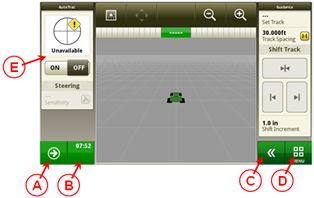 John Deere 4100 CommandCenter
John Deere 4100 CommandCenter

A. Next run page
B. Status center
C. Expand shortcut keys
D. Menu
E. Run page
 John Deere 4600 Command Center
John Deere 4600 Command Center

A. Next and previous run page
B. Status center
C. Shortcut keys
D. Menu
E. Run page
F. Title bar
Standard CommandView™ III cab offers unsurpassed amenities
 CommandView III cab
CommandView III cab

The Standard CommandView III cab offers unsurpassed visibility, operator comfort, control placement, and ride and sound quality.
Features:
- ComfortCommand™ seat with air suspension, lumbar support, swivel, fore-aft and lateral attenuation, backrest angle adjustment, adjustable left-hand armrest, and 40-degree right-hand seat swivel
- Operator presence system that warns if the operator is out of the seat while operating key functions
- Folding instructional seat
- CommandARM™ console with integrated controls
- 4100 or 4600 Generation 4 CommandCenter™display
- Behind-the-seat storage
- Left-hand storage compartment
- Passive noise reduction system
- Service ADVISOR™ data port
- Tilt/telescoping steering wheel with position memory
- Swing-out rear window, opens 30 degrees
- Right- and left-outside mirrors (manually adjustable mirror head)
- Monitor mounts on right-hand front post and rear cab post
- Standard radio package, including AM/FM stereo and weatherband with remote controls, auxiliary input jack, four speakers, and an external antenna
- Laminated glass
- Air conditioner and heater with automatic temperature controls (ATC)
- Two 12-V convenience outlet (cigarette lighter style)
- One 12-V 3-pin outlet with adapter (provides switched and unswitched power)
- One International Organization for Standardization (ISO) 9-pin connector
- Power strip with convenience plug adapter
- Hitch control lever lock and selective control lever lock
- Two-speed and intermittent front and rear wiper with washer
- Front pull-down sunshade
- Digital cornerpost display with:
- Fuel level gauge, including low fuel warning
- Temperature gauge
- Diesel exhaust fluid (DEF) gauge, including low DEF warning
- Engine rpm
- Transmission commanded gear or speed
- Vehicle system functions, such as iTEC™ system, that are operating
- Inside-mounted rearview mirror
- Beverage holders sized to accommodate various containers
- Interior left-hand dome light
ComfortCommand seat
 ComfortCommand seat
ComfortCommand seat

ComfortCommand seat improves ride quality and helps to reduce operator fatigue
Features include:
- Armrests, lumbar support, and backrest angle are easily adjusted to match operator preference.
- Shock absorbers dampen the motion effect of the tractor for an improved ride.
- Seat height adjustments are conveniently located on the left armrest.
- Fore-aft adjustment is easy to reach located on the left front of the seat.
- Swivel adjustment, located on the front of the seat, allows the seat to be swiveled 40 degrees to the right or eight degrees to the left of the center position.
- Operator presence switch warns if the operator is out of the seat while operating key functions.
- Seat belt retractor.
- Centered cab seat, providing excellent over-shoulder visibility.
- Adjustable shock absorber permitting ride adjustment from soft to firm to match the operator's desired comfort level.
- Removable cushions for easy cleaning.
CommandARM
 CommandARM controls
CommandARM controls

John Deere 7R and 8R Series Tractors feature the CommandARM with integrated Generation 4 CommandCenter display. The control layout of the CommandARM utilizes a clean and efficient design which groups controls by function and builds upon John Deere’s history of intuitive and ergonomic control placement and operation. The CommandARM’s design allows for a 40 degree right seat swivel and adjustable positioning matching the operator’s preference.
Controls located on the CommandARM include:
- Engine throttle
- FieldCruise™ system
- Minimum engine speed – CommandQuad™ transmission, 16-speed PowerShift™ transmission (PST), e23™ transmission
- Eco mode – Infinitely Variable Transmission (IVT™)
- Foot pedal lock (if equipped)
- Transmission control
- Hitch/selective control valve (SCV) controls
- Rotary encoder hitch control
- Power take-off (PTO) controls
- Mechanical front-wheel drive (MFWD) on/automatic
- Differential lock on/automatic
- iTEC sequence switches
- AutoTrac™ assisted steering system resume switch (if equipped)
- Joystick (if equipped)
- Radio
- Beacon light on/off
- Hazard lights on/off
- Field lights 1/2
- Heating, ventilation, air conditioning (HVAC) system
Transmission controls
John Deere 7R Series Tractors with CommandQuad transmissions feature a left-hand reverser. 8R Series Tractors equipped with 16-speed PST are equipped with right-hand reverser. 7R Series Tractors equipped with e23 PST offer a left- or right-hand reverser. 7R or 8R Series Tractors equipped with AutoPowr™/IVT transmissions are offered with either a left-hand or a right-hand reverser.
The transmission control lever is placed on the CommandARM’s left side closest to the operator for convenient setting and adjustment.
 Left-hand CommandQuad/e23 reverser
Left-hand CommandQuad/e23 reverser
 Right-hand IVT and PST reverser
Right-hand IVT and PST reverser
 16-speed PST right-hand reverser
16-speed PST right-hand reverser
Hydraulic and hitch controls
Hydraulic and hitch controls utilize fingertip paddle pots for raise/lower and extend/retract functions. An optional crossgate joystick replaces fingertip paddle pots for control of SCVs and allows for programmable hydraulic functionality according to operator preference. Rear hitch position can also be controlled with the encoder wheel located on the right side of the CommandARM. The encoder wheel allows for finite positioning of the rear 3-point hitch.
Three buttons near the encoder are for hitch set, lock, and return to height. Adjustment knobs for the 3-point hitch are located under the cover for the CommandARM’s storage compartment and allow for adjustment of the rate of drop, hitch height limit, and depth control.
 Fingertip paddle pots
Fingertip paddle pots
 Encoder wheel
Encoder wheel
 Hitch controls
Hitch controls
 Optional crossgate joystick
Optional crossgate joystick
Throttle
The throttle design incorporates buttons which control FieldCruise speed, foot pedal mode (if equipped), and transmission eco settings.
 Throttle
Throttle
 Foot throttle
Foot throttle
Tractor function controls
Located just to the right of the throttle is the Auto-Trac activation button and four sequence controls for iTEC functions. Behind the iTEC sequence controls, there are buttons which control the activation and deactivation of MFWD and differential lock. Differential lock can also be activated by the foot switch on the cab floor.
 AutoTrac resume and iTEC strip
AutoTrac resume and iTEC strip

Controls for radio, lights, rotary beacon (if equipped), hazard flashers, and HVAC system are located to the center-right on the CommandARM, along with PTO for both front (if equipped) and rear PTO.
 Radio, HVAC, hazard flashers, and PTO controls
Radio, HVAC, hazard flashers, and PTO controls

Seat swivel
The design of the CommandARM allows for up to 40 degrees of right-hand seat swivel.
 Seat swivel
Seat swivel

CommandCenter
 Generation 4 CommandCenter
Generation 4 CommandCenter

The Generation 4 CommandCenters feature fast adjustment of tractor functions and controls and are integrated into the CommandARM to create a seamless control center. The 4100 CommandCenter features a 178-mm (7-in.) touchscreen display and is standard equipment on 7210R and 7230R models, while the 4600 CommandCenter features a 154-mm (10-in.) touchscreen and is standard equipment on 7250R – 7310R models, as well as all 8R and 8RT models.
The following functions can be adjusted using the CommandCenter display:
- Hydraulic settings
- Hitch settings
- Transmission settings
- FieldCruise
- iTEC programming functions
- Radio
- Lights
Triple-Link Suspension Plus (TLS™ Plus)
 7R with TLS Plus
7R with TLS Plus

The optional TLS Plus is a fully integrated, self-leveling front suspension system available on 7R Series Tractors equipped with the 1300 mechanical front-wheel drive (MFWD) axle. TLS Plus provides exclusive front suspension using a hydro-pneumatic self-leveling system to increase productivity and improve ride dramatically. TLS Plus provides more control over the front suspension of the tractor.
 CommandCenter screen
CommandCenter screen

In the Generation 4 CommandCenter™, the operator is able to select maximum pressure to accommodate for the transfer of heavy loads with minimal front axle movement.
TLS Plus increases both transport and field productivity with superior stability, ride, and comfort. Loader operators appreciate the enhanced performance when transporting bales or a full bucket of silage. In the field, the TLS Plus front suspension maintains ground-to-tire contact, enabling more power to the ground.
The TLS Plus front axle is available with or without wet-disc front brakes. While TLS Plus is available on all 7R Series Large-Frame Tractors, it is a requirement for the following:
31-mph/50K CommandQuad™ Eco
31–mph/50K e23™
31–mph/50K infinitely variable transmission (IVT™)
TLS Plus components
 7R with TLS Plus
7R with TLS Plus
Two double-acting-control cylinders act independently or together to dampen shock loads, while supplying a constant down force on the axle for better traction. In addition to the cylinders, a pan-hard rod limits lateral motion while an electronic sensor signals a priority valve to automatically move the control cylinders as needed.
The cast driveline draft member controls fore-aft suspension of the axle. This heavy-duty conical casting encloses the entire driveline and transfers longitudinal forces to the tractor's center of gravity.
 1300 axle with TLS Plus
1300 axle with TLS Plus
 1300 axle cutaway with TLS Plus
1300 axle cutaway with TLS Plus
Operating characteristics:
- TLS Plus self-levels at engine start-up with the implement attached and the hitch in the raised or lowered position.
- TLS Plus self-levels whenever the tractor speed exceeds 0.9 mph (1.5 km/h).
Differential lock
 CommandARM™ controls with automatic differential lock engaged
CommandARM™ controls with automatic differential lock engaged
 CommandARM controls with manual differential lock engaged
CommandARM controls with manual differential lock engaged
The differential lock is another feature of the 1300 Series MFWD axle with Triple-Link Susspension (TLS) PLUS, driveline shield, hydraulic on/off differential lock, and wet-disk front brakes. When the rear differential lock is engaged or disengaged, the front differential lock is also engaged or disengaged. This also includes a driveline shield.
If one wheel begins to slip, the differential lock can be engaged on the go and the axles are hydraulically locked together for maximum traction. There are two ways to engage the differential lock feature.
- Manual differential lock - differential lock can be engaged manually using a switch on the floor or by manual depressing button on CommandARM. When brakes are depressed, the differential lock will disengage
- Automatic Differential lock - when in auto mode, differential lock is engaged when the tractor is driving forward. Differential lock will disengage when front wheel turn angle meets disengage wheel angle setting defined by the operator via the CommandCenter or when either brake pedal is depressed. Differential lock will automatically engage when brakes are released or front wheels are turned straight.
 Automatic differential lock angle adjustment
Automatic differential lock angle adjustment
The 7R Series cooling system
 7R Series cooling package
7R Series cooling package
 Pull-style fan and radiator access
Pull-style fan and radiator access
The 7R Series Tractors feature an increased front area (IFA) cooling system that utilizes a pull-style fan that improves cooling efficiency over an increased surface area that provides better cooling capacity and reduces fan noise during increased power levels or while under heavy loads.
 Hood screen area
Hood screen area
 Engine hood with side shields
Engine hood with side shields
The 7R Series Tractors also have an increased screen area on the hood and redesigned side shields to help reduce debris buildup. The new cooling system provides easy, cooler cleanout and service accessibility without sacrifice to turning radius or front hitch and front power take-off (PTO) applications.
Lighting packages provide 360 degrees of coverage for maximum productivity
 Premium lights
Premium lights

The 7R, 8R, and 8RT Series Tractors feature two lighting package options:
- Standard
- Premium
The cab lighting pattern provides 330 degrees of coverage while the hood lighting provides the remaining 30 degrees for completely programmable 360-degree, stadium-style lighting. This ensures there are no dead zones or lighting adjustments needed. The lighting configurations are available to match various applications and ensure maximum around-the-clock productivity.
Bulb housings are large, allowing for optimum total lumens and available light. The standard lighting packages use 65-W halogen bulbs, whereas the premium lighting package uses light-emitting diode (LED) lights. In the premium lighting package, these tractors take advantage of the high-performing and efficient LED technology.
The low- and high-beam driving/work lights are adjustable. Please refer to the electrical section in the operator’s manual for complete details on adjusting lights.
 7R/8R/8RT lighting
7R/8R/8RT lighting

Yellow circles
- All lighting packages: 65-W halogen: road low beam
Red circles
- Standard: 65-W halogen
- Premium: LED
Blue circles
- Standard: 65-W halogen; field and road high beams
- Premium: LED
Orange circles
- Standard: blank
- Premium: LED
|
Standard lighting
 Standard lighting (8R)
Standard lighting (8R)
 Standard lighting (7R)
Standard lighting (7R)
Six front grill-mounted lights:
- Two 65-W low-beam driving/work lights (mid grill screen)
- Two 65-W high-beam driving/work lights (top of grill screen, hood mounted)
- Two front corner-facing halogen work lights (top of grill screen, hood mounted)
10 cab roof-mounted lights:
- Two rear-facing 65-W floodlights
- Four side-facing 65-W floodlights
- Four corner-facing amber lights
Other lights:
- Two rear fender-mounted floodlights
- Two rear turn signal and brake/tail lights (fender mounted)
- Two folding-extremity lights
Plus these lights:
- Two adjustable front roof 65-W halogen floodlights
- Two front belt-line floodlights
- Rotary beacon light
Premium lighting
Eight front grill-mounted lights:
- Two 65-W low-beam halogen driving/work lights (mid grill screen)
- Two LED high-beam driving/work lights (top of grill screen, hood mounted)
- Two front corner-facing LED work lights (top of grill screen, hood mounted)
- Two front-facing LED working lights (top of grill screen, hood mounted, inner position on the sides)
12 cab roof-mounted lights:
- Four side-facing LED lights
- Four corner-facing amber lights
- Two rear-facing LED lights
- Two adjustable front roof LED lights
Other lights:
- Two rear fender-mounted LED lights
- Two rear turn signal and brake lights (fender mounted)
- Two folding-extremity lights
- Two front belt-line LED floodlights
- Rotary beacon light
The premium lighting package replaces all previous halogen and HID lights with LED lights. The only lights that are not LED are the low-beam driving lights, they remain halogen. This allows each LED light to work at a lower temperature and no one light works harder than any other. The uniformity in LED coverage allows only one type of light output surrounding the tractor.
The lighting pattern in the premium package provides industry-leading performance in nighttime visibility. LED bulbs provide maximum brightness and a true color output for excellent field definition that is easy on the operator's eyes.
The LED lights provide 40 percent greater coverage width and 10 percent more light coverage in the rear. LED lighting packages use 45 percent less amps than standard halogen lights and have an increased life expectancy over HID lights which leads to lower costs of ownership over the life of the tractor.
NOTE: Lighting packages may vary depending on region.
Selecting a lighting mode/programmable lighting
 Lighting mode selector
Lighting mode selector

Operators can quickly select a lighting mode on the steering console:
- Lights, off position
- Road lights
- Field lights
 The CommandCenter™ display
The CommandCenter™ display
The CommandCenter display allows operators to customize light settings. Operators can select only the lights they need or want for a given application and store these settings. The operator-programmed configurations can then be turned on or off with the push of a button on the CommandARM™ controls.
- Programmable field lights 1
- Programmable field lights 2
- Beacon light
- Emergency flashers
NOTE: Road/loader lights are also referred to as high-mounted driving lights for use in front hitch applications that obscure the headlights. See the Attachments section.
The battery power saver feature is also standard. When the engine is off and the outside lights have been left on, this feature is designed to avoid battery run down.
After the lights have been left on for 30 minutes and the key is in the off position, the lights cycle or blink on and off five times as an alert. The lights continue to illuminate for one more minute and then automatically shut off to protect the battery.
Programmable exit lighting
Another feature is programmable exit lighting. Exit lighting allows the lights outside the cab to stay on for up to 300 seconds. They can be programmed in increments from 0 to 300 seconds.
Refer to the operator’s manual for complete instructions on programming field, driving, and exit lighting.
Field-installed options
Field-installed options are also available. To find this information, use the Build Your own Configurator application for US/Canada or Build & Price in John Deere Sales Centre for Australia/NZ.
| Option code | Description |
| 7201 | Standard lighting |
| 7206 | Premium lighting |
e23™ transmission
 7R e23 transmission
7R e23 transmission

The e23 transmission delivers smooth shifting and intuitive controls with Efficiency Manager™ feature in a reliable 23-speed PowerShift™ transmission. The e23 transmission is available for all 7R, 8R, and 8RT Series Tractors.
The e23 has evolved from more than 50 years of John Deere PowerShift technology. With more automatic features, the e23 is easy to operate for all levels of operator experience. For more advanced operators looking to customize the transmission to best fit their operation, the e23 offers a custom mode.
As the next generation of PowerShift technology, e23 delivers the strength to handle sudden, high-torque power loads while maintaining responsive, quick, and smooth shifts. The e23 with Efficiency Manager provides improved fluid efficiency and overall productivity with limited input from the operator.
e23 options
- e23 transmission 42 km/h (26 mph) with Efficiency Manager
- e23 transmission 50 km/h (31 mph) with Efficiency Manager
Even gear spacing for optimal performance
The e23 has 23 forward gears and 11 reverse gears, which are all evenly spaced. Forward gears are spaced 15 percent apart, while reverse gears are spaced approximately 30 percent apart, providing operators smooth shifting between gears. Even spacing improves efficiency and allows for smooth, automated shifts when using Efficiency Manager. The e23 can reach maximum forward ground speed in gear F20. As a result, gears F21-F23 maintain maximum ground speed at reduced engine rpms to save fuel.
e23 controls
The e23 is available with either a right-hand or left-hand reverser.
 Right-hand reverser
Right-hand reverser

Right-hand reverser
A convenient, right-hand reverser is available with the e23 transmission. The reverser is located on the CommandARM™ as shown above.
- Forward direction selector
- Reverse direction selector
- Neutral position
- Electronic park lock
Right-hand reverser equipped models use three main controls to operate the tractor:
- Foot brake with integrated AutoClutch
- Set speed adjuster
- Gear selector control lever with integrated reverser
The right-hand reverser control strategy combines speed control and direction control into one multi-function lever that is conveniently located on the CommandARM. This is a good choice for most common field applications since tractor speed and direction are not constantly being adjusted by the operator.
Left-hand reverser
 Left-hand reverser
Left-hand reverser
 Left-hand transmission lever
Left-hand transmission lever
An easy-to-use left-hand reverser is available with the e23 transmission and includes the same functions as the right-hand reverser. The reverser control is located at the 10 o’clock position on the steering column for intuitive control.
The five-position, left-hand reverser column incorporates the following controls:
- Forward direction selector
- Reverse direction selector
- Neutral position
- Electronic park lock
Left-hand reverser equipped models use four main controls to operate the tractor:
- Foot brake with integrated AutoClutch™ function
- Set speed adjuster
- Gear selector control
- Multi-function left-hand reverser
The left-hand reverser control strategy separates the direction control lever from the speed/gear control lever on the CommandARM. This strategy is a good choice for operations requiring the right hand to run multiple operations on the CommandARM or applications requiring constant directional changes like loader work.
Determining which reverser is best suited for a specific operator depends on a few key factors. Consider the following to help choose between a left- or right-hand reverser.
- Operator preference and ergonomic benefits.
- Operators in loader applications might prefer a left-hand reverser since direction changes occur frequently while their hands are on the steering wheel (near the left-hand reverser location).
Producers primarily in row-crop applications using features like AutoTrac™ assisted steering system or operating with the seat swiveled to the right for easy access to monitors and displays might find the right-hand reverser more convenient. Speed and directional controls are in one location on the CommandARM.
Foot brake with integrated AutoClutch function
The electrohydraulically controlled brakes on e23-equipped tractors have an integrated AutoClutch function.
- At low idle only, the tractor will stop by depressing only one brake pedal.
- Pressing both brakes (locked together) simultaneously will stop the tractor from any ground or engine speed.
Braking can be done on flat ground or steep slopes simply by using the brake pedals; it is not necessary to depress the clutch.
- It is recommended to lock the brake pedals together when operating on roads.
 |
| Foot brake with integrated AutoClutch |
AutoClutch sensitivity can be adjusted through the Generation 4 CommandCenter™ display. AutoClutch can be deactivated on e23 transmissions as well; however, it will be reactivated after every key start.

Stopping the tractor using AutoClutch
During transport, it may be desirable to use the AutoClutch feature to stop the tractor when approaching an intersection or turn. Braking the tractor using the AutoClutch at high ground speed and engine speed will require high brake-pedal force.
Rather than using AutoClutch alone, reduce the engine rpm and reduce the e23 to a slower commanded speed before applying the AutoClutch. This will help to reduce the force needed to stop the tractor with the AutoClutch. The tractor will accelerate to the previously commanded speed upon release of the AutoClutch, repositioning of the hand throttle and increasing the commanded speed.
NOTE: The preferred method of stopping heavy towed loads is to reduce the e23 commanded speed and lower engine rpm first, and then depress both brake pedals. (Brake pedals should be locked together.)
Using individual brake pedals - implement hook-up
Individual brake pedals can be used to assist slow-speed off-road turning, such as hooking up to an implement. At low idle, the AutoClutch feature will stop the tractor if the operator depresses only one brake pedal.
To assist in hooking up an implement, depress either brake pedal while slowly increasing engine speed until the desired turn is achieved. Returning engine speed to a low idle while continuing to depress one brake pedal will slow the tractor to a stop.
CommandCenter™ controls
 254-mm (10 in.) Generation 4 CommandCenter
254-mm (10 in.) Generation 4 CommandCenter

The CommandCenter is the central information system for tractors and allows the operator to program various settings tailored to a specific operation.
To access the tractor’s transmission settings, press the transmission shortcut button on the CommandCenter shortcut bar.
 |
| CommandCenter transmission shortcut button |
Operating modes
The e23 application settings employ three modes to take full advantage of the engine-transmission communication: full auto mode, custom mode, and manual mode.
Full auto mode
 Full auto main page
Full auto main page

Full AUTO mode enables the tractor to make adjustments to the transmission operating mode automatically, based on engine and transmission speed and the load on the tractor. This means the tractor will shift up and throttle back automatically to reach the desired ground speed efficiently. Operators have the ability to set the maximum forward and reverse speeds for the tractor in their particular application.
When shifting in full AUTO mode, the transmission shifts set speeds, meaning the transmission may not necessarily shift gears each time the lever is bumped. Efficiency Manager is automatically engaged while operating in full AUTO mode. As a result, shifting will not take the tractor out of Efficiency Manager in full AUTO mode.
Custom mode
 e23 custom transmission page
e23 custom transmission page

Custom mode allows operators to adjust operating parameters to meet their specific operation. Just like full AUTO mode, custom mode shifts set speeds meaning the transmission may not necessarily shift gears each time the lever is bumped. Efficiency manager is engaged automatically in custom mode.
 Eco button
Eco button
 Display screen
Display screen
In custom mode, eco allows two minimum engine speeds to be set. Operators can turn eco on and off by either pushing the eco button on the side of the throttle or by selecting eco in the transmission settings page of the CommandCenter. For example, operators may choose to turn eco on during transport to utilize a lower minimum engine speed and then turn eco off while operating in the field where a higher minimum engine speed is desired.
 Custom settings page
Custom settings page

In the advanced settings page, operators can customize the auto shift engine speed droop as a percentage of the full engine speed. In addition, the load anticipation feature can be enabled for the hitch engagement, hydraulic engagement, or both.
Manual mode
 Manual mode page
Manual mode page

Manual mode operates similar to a traditional PowerShift transmission. When shifting, the transmission shifts gears, not set speeds like full AUTO and custom mode. Manual mode also features efficiency manager when the operator engages set speed one or two on the CommandARM, as shown above in illustration.
When operating in manual mode with efficiency manager active, there is the option of turning eco on or eco off. This allows the operator to select two different minimum engine speeds. In the advanced settings page, operators can adjust auto shift engine speed droop and load anticipation, similar to custom mode.
Advanced transmission settings
Additional transmission settings can be customized to the operators’ specific desires.
AutoClutch sensitivity can be adjusted on the transmission settings page in the CommandCenter display. Operators can turn off AutoClutch or choose from high, medium, or low sensitivity. Operators can fine-tune AutoClutch by delaying the response time, based on load, travel speed, etcetera. This allows the trailer brakes to be applied before AutoClutch engages.
- High: for light or no trailer (load) – factory default
- Medium: for medium trailers (load)
- Low: for heavy trailers (load)
- AutoClutch Off: to operate e23 just like a traditional powershift
The AutoClutch sensitivity factory default-setting is set to high, which supports most operations.
AutoClutch sensitivity settings are available in all three modes – auto, custom, and manual.
Efficiency manager
 |
| Set speed buttons and set speed adjuster |
Efficiency manager is automatically enabled in full AUTO and custom mode. Efficiency manager can be turned on in manual mode by selecting the set speed one or two on the CommandARM. The set speed adjuster on the top of the single-lever gear selector allows the operator to dial in the desired ground speed to establish set speed one or two in Efficiency Manager.
Efficiency manager allows the transmission to up or down shift and change engine rpm to maintain the set wheel speed. To reach the desired set speed, the throttle must be set to full engine rpm. This allows efficiency manager to shift the transmission and adjust engine speed to maintain the desired wheel speed. For more information on Efficiency Manager refer to the operator’s manual.
e23 operation
Both right-hand reverser and left-hand reverser control options provide full powershifts for on-the-go shifting; no need to stop or clutch when bump shifting or shuttle shifting between forward and reverse.
The single-lever shifter allows for quick and convenient shifting with minimal physical effort.
Shifts are made either by bumping the lever or by holding the lever in a forward or rearward position.
- Transmission is in neutral when the shift control or left-hand reverser is not in park, forward, or reverse.
- Operator presence feature prevents the transmission from going into gear when the operator is not seated or has the brake or clutch pedal depressed.
- Transmission can be programmed to start in 1F – 13F or 1R – 6R.
A forward gear between 1F and 13F may be preselected by depressing the clutch pedal and pushing or pulling the shift lever. The transmission will then start in the preselected forward gear when clutch pedal is released.
 Cornerpost display
Cornerpost display

The cornerpost display shows the commanded gear instantaneously once selected.
| Option code | Description |
| 1493 | e23 Transmission 42 km/h (26 mph) with Efficiency Manager |
| 1494 | e23 Transmission 50 km/h (31 mph) with Efficiency Manager |
| 2701 | Right-hand Reverser Bump-Shift-Type Transmission Controls |
| 2702 | Left-hand Reverser Bump-Shift-Type Transmission Controls |
Rapid shifting
 Rapid shifting
Rapid shifting

When the tractor is working in a light-load condition, for example in transport, the transmission can be shifted rapidly by bumping the shift lever.
To reach transport speeds quickly:
- Depress clutch pedal and rapidly bump shift lever to 13F
- Transmission will shift directly to 13F when clutch pedal is released
- Transmission will skip some gears as it keeps up with the operator’s command, allowing the tractor to accelerate to transport speed quickly
- Once tractor is underway in 13F, bump the shift lever to reach desired ground speed
Double shifting
The transmission can skip a gear when operating under load by double bumping the shift lever.
- This aids the ease of deceleration/acceleration when approaching and departing headland turns.
Ground speed matching
When the tractor is slowing down and the clutch pedal is depressed, the transmission will match a gear to the ground speed of the tractor when the clutch is released. Ground speed matching only engages in gears 13F higher.
Setting start-up gears
The transmission defaults to 8F and 3R at start-up. However, these default start-up gears can be adjusted from 1-13F and 1-6R through the CommandCenter. Refer to the operator’s manual for additional information.
 |
| Start-up gears in advanced settings |
Releasing the park brake
The e23 transmission utilizes a spring-engaged/hydraulically-disengaged park brake. The park brake control feature prevents accidental park brake engagement when tractor is moving at high speed.
On tractors equipped with air brakes, the park brake automatically activates the air brake system.
ActiveSeat™ seat utilizes electrohydraulic technology with air suspension
 ActiveSeat and controls
ActiveSeat and controls

John Deere’s ActiveSeat utilizes electrohydraulic technology in combination with air suspension, providing the operator with enhanced ride quality over standard air-suspension seats.
Operator movements are monitored in order to reduce vertical movement. An ActiveSeat suspension can isolate the operator from up to 90 percent of vertical movements typically seen in tractor applications.
The system uses a hydraulic cylinder that is connected to a control valve assembly. Electrohydraulic valves located in the control valve assembly automatically react to inputs from two sensors, a position sensor and an accelerometer. Inputs from these two sensors control oil flow from the tractor to the hydraulic cylinder to reduce the vertical movement of the operator.
 ActiveSeat left armrest
ActiveSeat left armrest

The John Deere ActiveSeat has many of the same features of the ComfortCommand™ seat with the addition of a ride firmness switch. The ride firmness switch is located on the left-hand armrest and replaces the suspension shock-dampening seat attenuation lever on the front right-hand side of the ComfortCommand seat controls.
The ride firmness switch has three positions: plus, minus, and mid position. The three positions provide three different levels of seat performance:
- The plus position provides the greatest degree of ride firmness. This position allows more of the tractor's inputs to be felt by the operator (slightly rougher ride).
- The minus position provides the least degree of ride firmness, allowing minimal tractor inputs to reach the operator, resulting in maximum seat performance.
- The mid position allows a balance between the plus (+) and minus (-) settings.
The ActiveSeat is also available as a heated leather seat for increased comfort and easier cleaning. For tractor applications where operating speed is not limited by the implement, the ActiveSeat can allow for faster field speeds and increased overall comfort and productivity.
NOTE: The John Deere ActiveSeat is not available on track tractors.
| Option code | Description |
| 2061 | Premium CommandView III Cab with Active Seat |
ISOBUS and tractor-baler automation offer new baling experience
Tractor-Baler Automation simplifies baling experience
 A single manual action; system manages the rest
A single manual action; system manages the rest
 TBA awards
TBA awards
The optional Tractor-Baler Automation (TBA) makes baling easy. This exclusive system manages most of the baling process and gives the customer the following advantages:
- High baling comfort a single action to bale instead of four.
- Error proof baling - even after 10 working hours, the system does not forget any action; a true advantage for an inexperienced driver.
- Constant bale quality - same diameter bale after bale
- Constant productivity - no reduced efficiency due to operators fatigue.
When used with a John Deere ISOBUS tractor, electric selective control valve (E-SCV), and (IVT™) transmission, the system will be able to:
- Stop the tractor when bale size is reached
- Wrap the bale
- Open the gate
- Close the gate when bale is unloaded
The only action remaining is to forward reverser and manage the steering.
If the John Deere tractor is not equipped with IVT but has E-SCV and ISOBUS, opening and closing can be automated.
A single touch on SCV, brakes, or reverser will disengage the automation. In the same way, automated open/close can be momentarily stopped when unloading in hilly conditions.
Tractor-Implement Automation is an exclusive green on green advantage. This advanced technology option has won awards at SIMA and Agritechnica farm equipment show in Europe, a true cost/value guarantee.
NOTE: to run through fully automated mode, a John Deere Isobus tractor with E-SCV and IVT is required. A baler activation key and a tractor activation key (different) have to be ordered.
ISOBUS certified balers
 Plug in and bale with ISOBUS
Plug in and bale with ISOBUS
 ISOBUS certified = compatibility guarantee
ISOBUS certified = compatibility guarantee
The 990 and 960 Balers offer ISOBUS compatibility as base equipment. This standardized communication not only allows the use of John Deere Greenstar2 1800, 2600, or 2630 Displays, but also the use of other ISOBUS conform competitive monitors.
Adapter harnesses for non-ISOBUS tractors are available.
User friendly interface
 Main page with simple and clear pictograms
Main page with simple and clear pictograms
 Bale or soft core density adjustments
Bale or soft core density adjustments
The Baler interface displays information that is needed. The 900 Series monitors provide all required information:
- Bale shape and diameter
- Drop floor and knives position
- Variable core activation
- Tying process status
- Gate position
- Maintenance status
Adjustments can also be managed from the operators station:
- Bale size and density
- Variable core diameter and density
- Net and twine tying parameters
- Knife selection
- Automated lubrication
- Tractor-Baler Automation status
- Bale counter resets
Greenstar™2 1800 has the ideal display for baling application
 Greenstar2 1800 Display ordered with the baler
Greenstar2 1800 Display ordered with the baler

The 900 Series Balers can be teamed with all ISOBUS certified displays. The Greenstar2 1800 monitor can be ordered with the baler to match traditional baling requirements. When not baling this display can be used for other functions such as guidance and spraying applications when connected to an appropriate receiver and implement.
All ISOBUS display will fit the 900 Series
 GreenStar3 2630 fits the most demanding user needs
GreenStar3 2630 fits the most demanding user needs

The 960 and 990 Balers can be ordered without a monitor for customers who already have an ISOBUS display, or for those who search more advanced application (field management). Displays other than John Deere Greenstar2 1800 can be purchased through Ag Management Solutions (AMS) pages.
Front hitch options fit a variety of applications
 7R Series Tractor with front hitch
7R Series Tractor with front hitch

The 7R Series Tractors offer two front hitch options to best fit a variety of applications.
Standard (non-ground-engaging) hitch option for applications including, but not limited to:
- Front-mounted mowers, toppers, and snow blowers
- Carrying front seed hoppers and plow packers
- Carrying front ballast
- Operating light-draft implements
Premium (ground-engaging) hitch option for applications including, but not limited to:
- Operating primary tillage equipment and standard blades
Premium hitches include a push bar and heavier lift arms:
- Hitches with zero front auxiliary valves include one mid-mount valve.
- Hitches with one front auxiliary valve include two mid-mount valves.
- Hitches with two front auxiliary valves include three mid-mount valves.
To ensure adequate hydraulic availability, up to two selective control valves (SCVs) can be included with a front hitch.
 Joystick control
Joystick control
 Paddle pot SCV
Paddle pot SCV
Tractors equipped with a factory front hitch have the option of selecting a joystick control or paddle pot SCV controls. The joystick control is not compatible with the sixth rear electrohydraulic SCV because of the CommandARM™ controls space required for the front hitch joystick.
Features of John Deere factory-installed front hitches include:
|
Standard |
Premium |
Lift capacity at ball ends (ISO) |
5200 kg (11,464 lb) |
5200 kg (11,464 lb) |
Lift range |
750 mm (29.5 in.) |
750 mm (29.5 in.) |
Overhang when folded |
55 mm (2.2 in.) |
55 mm (2.2 in.) |
Approach angle (depending on tire and axle setup) |
25.5 - 38.7 degrees |
25.5 - 38.7 degrees |
Reinforcing push bar |
Field-installed option |
Standard |
Auxiliary valve with front couplers |
Optional |
Standard |
Category 3N hitch |
Standard |
Standard |
7-pin connector - for implement lights |
Standard |
Standard |
9-pin harness and connector (ISO) |
Field-installed option |
Field-installed option |
Front-mounted remote switch |
Standard |
Standard |
Hitch damping |
Triple-Link Suspension (TLS™) axle, same effect |
TLS axle, same effect |
Hydraulic mode select |
Single and dual |
Single and dual |
Electronic position control |
Yes |
Yes |
Full ground clearance |
Yes |
Yes* |
iTEC™ compatible |
Yes |
Yes |
Power take-off (PTO) compatible |
Yes |
Yes |
Installed weight (with push bar)** |
-- |
455 kg (1003 lb) |
Installed weight (no push bar)** |
345 kg (760 lb) |
-- |
*Hitches with a push bar maintain front axle to ground clearance for row-crop applications and can be used with ground-engaging implements, including primary tillage implements and standard blades.
**Equals weight of added hitch components.
The integrated and styled compact hitch design maintains full maneuverability even with the larger front tires. The hitch extends only 55-mm (2.2-in.) ahead of the front support when the arms are folded.
Standard (carrier version) hitches can be converted to a premium (ground-engaging) hitch by ordering and field installing a conversion kit that includes push bar and heavier lift arms.
All factory-installed front hitches are capable of single- and dual-acting hydraulic cylinder modes. This allows the operator the flexibility to choose the correct mode for a variety of front hitch applications. Single acting provides hydraulic force for retracting the front hitch cylinders and allows front implements to follow the contour of the ground or surface. For example, this would be the correct mode for a front-mounted snow blower. Dual acting provides hydraulic force in retracting and extending the front hitch cylinders to provide down force for ground-engaging implements.
Additional hitch features include:
- Integrated and protected routing of oil lines
- Category 3 top link with storage position
- Integrated towing clevis with pin
- Compatible with group 42 - 44 front tires
 7R position sensing
7R position sensing

The 7R with front hitch comes equipped with position sensing that allows operators the ability to establish an upper height limit set point and lower limit set point through CommandCenter™ display. Position sensing maintains the height of the hitch arms based on the set points.
Position sensing provides the following benefits:
- Add to iTEC™ display sequence (raise/lower set points)
- Limit height for front-PTO implement (stay within desirable driveline angles)
- Set lower position for ground-engaging depth or blade position
- Maintain set height without added fixed link (position will auto correct)
- Prevent inadvertent hitch operation outside of desired range of motion (takes guesswork out of placing height of front implement)
- Less fatiguing for repetitive-type work where the same position is required over and over
For a 9-pin connector, order kit RE322555. The kit includes all necessary components and allows ISO implement communication.
NOTE: 7R Series Tractors with a factory-installed front hitch do not ship with a front weight support.
Front hitch – Field-installed options:
For more information on ordering a front hitch ready configuration, refer to Attachments, front hitch/power take-off (PTO) ready
For tractors ordered non-hitch or non-hitch ready please contact LaForge® company for front hitch options.
Laforge Systems Inc.
4425-C Treat Blvd. #230
Concord, California 94521
Phone: (925) 827-2010 or 1-800-422-5636
Web site: www.fronthitch.com
LaForge is a trademark of Laforge Corporation.
Front hitch options:
- Standard front hitch with zero front couplers, 5200-kg (11,450-lb) maximum lift capacity at hitch balls
- NOTE: 3150-kg (6944-lb) International Organization for Standardization (ISO) lift capacity.
Less push bar (hitch raise/lower hard plumbed to mid-mount valve)
Includes zero front auxiliary couplers.
ISOBUS connector available through Parts.
- NOTE: 3150-kg (6944-lb) International Organization for Standardization (ISO) lift capacity.
- Standard front hitch with one front auxiliary coupler, 5200-kg (11,450-lb) maximum lift capacity at hitch balls
- NOTE: 3150-kg (6944-lb-) ISO lift capacity.
Less push bar (hitch raise/lower hard plumbed to mid-mount valve)
Includes one front auxiliary couplers.
ISOBUS connector available through Parts.
- NOTE: 3150-kg (6944-lb-) ISO lift capacity.
- Premium front hitch with one front auxiliary coupler, 5200-kg (11,450-lb) maximum lift capacity at hitch balls
- NOTE: 3150-kg (6944-lb) ISO lift capacity.
Includes push bar (hitch raise/lower hard plumbed to mid-mount valve)
Includes one front auxiliary couplers.
ISOBUS connector available through Parts.
- NOTE: 3150-kg (6944-lb) ISO lift capacity.
- Standard front hitch with two front auxiliary couplers, 5200-kg (11,450-lb) maximum lift capacity at hitch balls
- NOTE: 3150-kg (6944-lb) ISO lift capacity.
Less push bar (hitch raise/lower hard plumbed to mid-mount valve)
Includes two front auxiliary couplers.
ISOBUS connector available through Parts.
- NOTE: 3150-kg (6944-lb) ISO lift capacity.
- Premium front hitch with two front auxiliary coupler, 5200-kg (11,450-lb) maximum lift capacity at hitch balls
- NOTE: 3150-kg (6944-lb) ISO lift capacity.
Includes push bar (hitch raise/lower hard plumbed to mid-mount valve).
Includes two front auxiliary couplers.
ISOBUS connector available through Parts.
- NOTE: 3150-kg (6944-lb) ISO lift capacity.
- CommandARM™ paddle pot SCV controls
- NOTE: Not compatible with joystick control.
Provides proportional paddle pot SCV control for mid-mount valve(s).
- NOTE: Not compatible with joystick control.
- Joystick control
- NOTE: Does not include mid-mount valve or loader-ready components.
ISOBUS compatible.
Not compatible with six rear SCVs.
Not compatible with CommandARM SCV controls.
- NOTE: Does not include mid-mount valve or loader-ready components.
Steering
The steering system uses load sensing of hydraulic pressure required to efficiently complete the designated tasks. The pressure- and flow- compensating pump produces excellent stationary or creeping ground speed steering response to handle demanding applications.
ActiveCommand Steering (ACS™)
 7R in transport
7R in transport

With ACS, John Deere has designed one of the most robust and full-encompassing steering system in the industry. Whether in the field or on the road, ACS reduces steering effort, which can result in reduced operator fatigue and can improve operator comfort.
There are four key features of the ACS system:
Dynamic road wheel offset
- A gyroscope senses tractor yaw and can automatically make small steering adjustments to provide unprecedented line-holding abilities. Drive down a bumpy road and experience how ACS makes it easier to keep the tractor straight, even over rough terrain. ACS delivers the ultimate in comfort.
- ACS works to prevent oversteering when a sudden obstacle causes the operator to make a quick steering reaction.
Variable ratio steering
- Approximately 3.5 turns lock to lock at in-field speeds for quick headland turns.
- Approximately 5 turns lock to lock at transport speeds.
Elimination of steering slop and hand wheel drift
- Steering wheel drift and slop are eliminated with the ACS electronic control system.
Variable effort steering
- Steering wheel resistance automatically changes with ground speed to deliver light steering effort at slower speeds for less effort during headland turns, and higher steering wheel torque at transport speeds for better operator comfort.
A fail operational system
The ACS system is fail operational, which means steering is still functional in the event of any single-point failure. John Deere has gone to great lengths to help ensure the operator can steer the tractor if something goes wrong in the steering system.
For example, if the primary controller fails, a second controller takes over. If power from the alternator is lost, the battery resumes control. If the engine quits running and is unable to supply hydraulic oil to the system, an electric-driven backup pump is used to supply the oil.
 ACS components
ACS components

The ACS system consists of several key components:
- Gyroscope: this is used to measure the yaw rate (turn rate) of the tractor during transport speeds.
- Road-wheel angle sensors: these sensors simply measure the steer angle of the tractor.
- Power supply module: this module distributes the power of the battery and alternator throughout the ACS system.
- Hand-wheel angle sensors and tactile feedback unit: this includes the steering wheel position sensors and a brake, which can increase or decrease resistance dependent on speed. Lighter feedback is desired during normal field use, and slightly heavier feedback is desired during transport and while the tractor is cornering at high speeds.
- Controllers: two controllers are located in the back of the tractor and are the brains of the system.
- Control valves: also known as steering valves, control valves are used to steer the tractor.
- Electric-drive backup pump: this pump supplies oil to the steering system, brakes, and park brakes (for towing) if there is no longer a sufficient oil supply to the steering and brakes.
Value of ACS
- Improves line holding when driving at transport speeds
- Fewer turns lock-to-lock: 3.5 turns lock-to-lock in the field for quicker headland turns and 5 turns lock-to-lock at transport speeds
- Eliminates hand-wheel backlash and drift
- Reduces steering effort, resulting in reduced operator fatigue
- Smaller hand-wheel diameter for improved operator comfort and visibility
- Maintains operator feel and touch points of traditional steering column system
- Fully integrates with AutoTrac™ guidance system
- Compatible with suspended and non-suspended front axles
- Compatible with wide- and narrow-section width tires
| Option code | Description |
| 1833 | John Deere ActiveCommand Steering (ACS) |
Features
CommandCenter™ display
Overview
The Generation 4 CommandCenter creates the primary user interface for 6R Series Tractors. The Generation 4 CommandCenter provides an excellent, user-savvy operating experience.
Producers can also use a variety of implements with the Generation 4 CommandCenter as it is ISOBUS virtual terminal (VT) capable.
Expect machine productivity gains, along with increased operator confidence, thanks to a simple, customizable interface. The reliability of the Generation 4 CommandCenter also aids in optimal operating experience and maximizes uptime.
 4200 CommandCenter 21.3-cm (8.4-in.) display
4200 CommandCenter 21.3-cm (8.4-in.) display
 4600 CommandCenter 25.4-cm (10-in.) display
4600 CommandCenter 25.4-cm (10-in.) display
Benefits
- Easy-to-change fields and guidance lines
- Custom-defined views
- On-screen help functions
- Intelligent warnings
- Context-based help
Details
| Code | Description |
| 1947 | 4200 Processor (21.3-cm [8.4-in.] display only) |
| 1946 | 4600 Processor (25.4-cm [10-in.] display only) |
| Code | Description |
| 1829 | 21.3-cm (8.4-in.) CommandCenter display (4200 Processor only) |
| 1822 | 25.4-cm (10-in.) CommandCenter display (4600 Processor only) |
| Code | Description |
| 1867 | Less application |
| 1851 | CommandCenter AutoTrac™ activation |
| 1858 | 4200 Section Control and Data Sync activation plus CommandCenter AutoTrac activation |
| 1857 | 4600 CommandCenter Premium Activation 3.0 |
| 1861 | 4600 CommandCenter Automation Activation 1.0 |
| 186S | 4600 CommandCenter Automation Activation 3.0 |
NOTE: CommandCenter AutoTrac activation stays with the tractor.
NOTE: 6155RH only available with code 1867.
 Help center main page
Help center main page
Additionally, application-based help is also available in all locations of the CommandCenter. Simply click on the (i) icon available on the title bar and it will lead directly to more information on the application currently being used.
Display options
Generation 4 CommandCenter displays are available in the following configurations:
- 21.3-cm (8.4-in.) display on the 4200 CommandCenter
- 25.4-cm (10-in.) display on the 4600 CommandCenter
For those wanting to maximize their viewing real estate, the 25.4-cm (10-in.) touchscreen color display is an excellent choice. With the 25.4-cm (10-in.) display, the title bar and all shortcut keys may be viewed at all times. Operators can monitor more items at once on the 25.4-cm (10-in.) touchscreen display.
Layout Manager
 Layout Manager selection page
Layout Manager selection page
 Layout Manager module build
Layout Manager module build
The Generation 4 CommandCenter features a modular-designed layout manager so an operator can easily create the structure that meets the operator’s demands. From the factory, machines are equipped with standard run pages. An unlimited amount of run pages can be added to the Generation 4 CommandCenter based on operator preference or operational needs. Toggling between run pages is as easy as swiping the screen or using the arrow buttons on the top right portion of the title bar.
Users and access
Users and access allow the owner to lock out certain functions to prevent operators from accessing or changing settings. Lock-out functions are managed with an owner-defined four-digit code.
Lockout features are available for:
- Precision Ag Technology applications
- Hitch
- Hydraulic
- Transmission
- Power take-off (PTO)
- FieldCruise™ engine controls
- Display
- Machine monitor
On-screen help and diagnostic text
There are a number of different ways to get meaningful on-screen help when navigating the Generation 4 CommandCenter. Operators can find the help icon on the shortcut bar on the bottom of every page. This icon gives detailed information on everything from tractor operation to application information. Simply select the help icon and navigate to the information section that is needed.
Work monitor
 Work monitor page
Work monitor page
The work monitor application displays the performance information about the task being performed by the machine. The user is shown averages, totals, and productivity of the machine, such as area worked, average working speed, and fuel usage. The values of the work monitor can be reset by the user at any time. Specific values of the work monitor can be configured by the user to be shown on a run page.
NOTE: The work monitor application replaces part of the universal performance monitor in previous machines.
Video capability
Tractors with a 4200 CommandCenter are equipped with one video input and tractors with a 4600 CommandCenter have two video inputs. The operator has the ability to set a variety of triggers, including reverse, PTO, hitch, and selective control valve (SCV) levers to activate the camera. The image will then appear on the CommandCenter display. The camera (video observation system) is available through JD Parts and Ag and Industrial (A & I) Products.
John Deere Generation 4 CommandCenter processors
A Generation 4 CommandCenter is made up of a processor and a display. Two processor options are available for the Generation 4 CommandCenter.
The 4600 Processor is the premium processor. Available features with the premium processor include:
- Compatible with 25.4-cm (10-in.) touchscreen display
- Two video camera inputs
- One USB input
- AutoTrac capable (machine-specific activation sold separately)
 Context-based help iTEC™ main page
Context-based help iTEC™ main page
Diagnostic text and information is available for better understanding of whether applications are operating as directed.
Machine monitor
 Machine monitor page
Machine monitor page
The machine monitor application provides the user instantaneous readings about the status or condition of the machine. Values shown in the machine monitor vary by application, but typically include parameters like engine speed, coolant temperature, and ground speed. The machine monitor supports run page modules in the layout manager, allowing the user to populate specific machine parameters directly to a run page.
NOTE: The machine monitor application replaces part of the Universal Performance Monitor in previous machines.
 25.4-cm (10-in.) 4600 CommandCenter display
25.4-cm (10-in.) 4600 CommandCenter display
The 4200 Processor is base equipment on all 6R Tractors. It offers:
- Compatible with 21.3-cm (8.4-in.) touchscreen display
- One video camera input
- One USB input
- AutoTrac capable (machine-specific activation sold separately)
| Tractors | 4600 Processor | 4200 Processor |
| 6R | Option | Standard |
 John Deere 4200 CommandCenter
John Deere 4200 CommandCenter
A. Next run page
B. Status center
C. Expand shortcut keys
D. Menu
E. Run page
 John Deere 4600 CommandCenter
John Deere 4600 CommandCenter
A. Next and previous run page
B. Status center
C. Shortcut keys
D. Menu
E. Run page
F. Title bar
DirectDrive
Overview
The DirectDrive transmission combines the efficiency benefits of a manual shift transmission with easy handling similar to the AutoPowr™/IVT™ transmission. DirectDrive utilizes unique double-clutch technology giving 6R operators more driving comfort.
Since this is a mechanical transmission, it provides smooth shifting between gears with high efficiency. Smooth shifting is achieved by excellent modulation between the dual clutches in combination with engine rpm management to speed match the next gear.
DirectDrive uses efficiency manager to automatically change up gears and throttle back, similar to how AutoPowr varies its ratio to achieve minimum engine rpm with a higher transmission ratio.
 The best of both worlds - efficiency and comfort
The best of both worlds - efficiency and comfort
Benefits
- Excellent mechanical power transfer
- Double-clutch technology (unique to PowerShift™ transmissions)
- Ranges perfectly fitted to agricultural applications – less need of range shifts
- Very good reduction in engine rpm at 40 km/h (25 mph). An operator concept that allows transmission control similar to an infinitely variable transmission.
- AutoClutch™ function
- Three set speeds and cruise control button
Details
| Code | Description | Available for | Information |
| 1530 | DirectDrive – 40 km/h (25 mph) | 6175R, 6195R, 6215R | Double clutch transmission, 40 km/h (25 mph) at reduced engine speed |
The modular concept
The DirectDrive transmission consists of the range box, the dual-path module, and the PowrReverser™.
Range box
The range box in the 6R Series consists of three ranges perfectly suited for agricultural applications.
- Range A: 2.7 km/h to 10.8 km/h (1.6 mph to 6.7 mph)
- Range B: 5.4 km/h to 22 km/h (3.3 mph to 13.6 mph)
- Range C: 13 km/h to 40 km/h (8 mph to 25 mph) at 1550 rpm
Changing from ranges is quick and simple and due to its adaptation to agricultural applications, it is hardly ever required in the field. Less range shifting means fewer torque interruptions.
 40 km/h (25 mph) during transportation
40 km/h (25 mph) during transportation
Ideal ranges for all needs (40 km/h [25 mph] version)
![Ideal ranges for all needs (40 km/h [25 mph] version)](https://salesmanual.deere.com/sales/salesmanual/images/NA/tractors/6r/range_40.jpg) Ideal ranges for all needs (40 km/h [25 mph] version)
Ideal ranges for all needs (40 km/h [25 mph] version)
Dual-path module
Overview
The dual path module includes the eight PowerShift gears, available in all three ranges. The PowerShift gears can change automatically, creating a very efficient drive strategy to save fuel and reduce noise.
The main technical innovation is the use of two clutches in one transmission. This system allows very fast shifting between gears and is highly efficient. The second gear is already lined up, ready to go, and just waiting for the change command to be given.
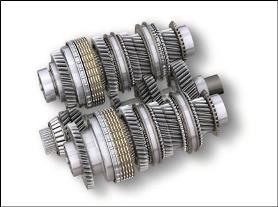 Dual-path module PowerShift gears
Dual-path module PowerShift gears
Left-hand reverser
Overview
An easy-to-use left-hand reverser is available in all the DirectDrive transmissions. The reverser control is located at the 10 o’clock position on the steering column for intuitive control. The left-hand reverser incorporates the following controls:
- Forward direction selector
- Reverse direction selector
- Park (P) – park lock (P) - tractor cannot move and the trailer brakes are engaged. Lever must be in the (P) park position to start the tractor.
- Neutral (N) - tractor is in a non-parked position and capable of movement.
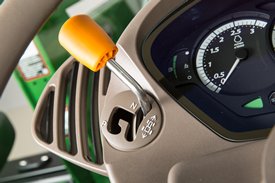 Left-hand reverser
Left-hand reverser
Benefits
- Quick and easy way for the operator to make powered changes in the direction of the tractor.
- Ensures that the tractor cannot be operated with the park brake engaged.
Electronic hand and foot throttle
Overview
The tractor ground speed is controlled via the accelerator and hand throttle. The engine rpm can be set to a specific ground speed using the hand throttle (A). Button (B) activates and de-activates FieldCruise™ (with two available pre-sets), which is an engine rpm limiter. The specific ground speed can be set by pressing button (C), this pedal lock feature works like the cruise control on a car. Button (D) allows the operator to drive with the minimum target rpm with eco on; note button (D) is only active in custom mode.
 Hand throttle
Hand throttle
 Foot throttle
Foot throttle
Benefits
- Pedal lock function allows command foot throttle speed to be maintained
- Define setting of the engine speed and its limit with FieldCruise
- Quick attainment of desired speed
Gear and range views in display
Overview
In the DirectDrive transmission, the selected range and selected PowerShift gear can be viewed in the dashboard.
Similar to the AutoPowr/IVT transmission control and display, the DirectDrive transmission has the red lights inside the speed display so the operator can see how fast the tractor will go at full commanded speed. This is adjusted using the speed wheel on top of the shift control lever.
 Ranges A, B, C, and PowerShift steps are displayed on the dashboard
Ranges A, B, C, and PowerShift steps are displayed on the dashboard
 Set speed indicated in the dashboard
Set speed indicated in the dashboard
Cab ComfortView™ Premium Plus – CommandARM™
Overview
The DirectDrive transmission can only be equipped on the CommandARM.
 DirectDrive control unit
DirectDrive control unit
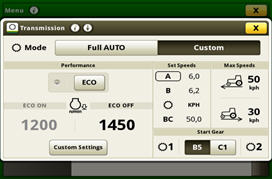 Custom mode settings on CommandARM
Custom mode settings on CommandARM
- Auto shift engine speed droop
If the tractor runs under full load, the gear shifting can be customized with this setting.
In custom mode the engine droop settings can be defined between 6 percent and 40 percent with power take-off (PTO) on and off. The higher the droop percentage, the more the engine rpm will be reduced when pulling before a transmission down shift is made.
A speed droop expressed as percentage of full engine speed can be chosen:
- Between 6 percent and 40 percent with PTO off
- Between 20 percent and 40 percent with PTO on
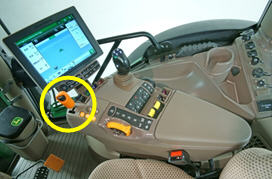 Control unit integrated into CommandARM
Control unit integrated into CommandARM
DirectDrive control unit
Overview
The DirectDrive control unit consists of the speed control lever, which has an ergonomically integrated set speed adjusting wheel. The set speed adjusting wheel is a rotational thumbwheel located on the speed control lever. The wheel is quick and easy to adjust with the thumb and rotates infinitely with no stop or start position. When the operator rotates the thumbwheel, the maximum commanded forward/reverse speed is set. Also integrated are three buttons to set the ranges.
- Range buttons
- Quick and precise speed changes with the A, B, B/C- range shift buttons
- Selection depends on the work to be done
- Range A: Heavy draft work
- Range B: Secondary tillage, mowing
- Range B/C: Transport (includes automatic range shift from range B to C)
- Speed lever
- Ergonomically integrated speed wheel to infinitely adjust the speed
- Two-function slot to set the eight PowerShift gears; auto mode and manual mode
- Easily change between modes using only the speed lever, without using the clutch
 Thumbwheel located on the speed control lever
Thumbwheel located on the speed control lever
Manual mode
Overview
In this mode, the operator manually changes the gears. Put the lever up (+) to select a higher gear and put the lever down (-) to select a lower gear. In this mode the throttle and transmission are independent, efficiency manager is only effective in auto mode.
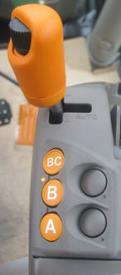 DirectDrive speed lever in manual mode
DirectDrive speed lever in manual mode
Full auto mode
Overview
If the lever is put in the right position, the auto mode is selected and the transmission shifts automatically, depending on the engine load and speed.
 DirectDrive speed lever in full auto mode
DirectDrive speed lever in full auto mode
CommandCenter™ settings – Full auto mode
Overview
Full auto mode enables the tractor to make adjustments to the transmission operating mode automatically, based on the engine and transmission speeds and the load on the tractor.
Full auto mode switches between load control and fuel economy mode seamlessly, with no involvement from the operator, as conditions and applications change. Fuel economy mode automatically switches off when the PTO is engaged to provide full PTO power. Operators can set the maximum forward and reverse speeds for the tractor in their particular applications.
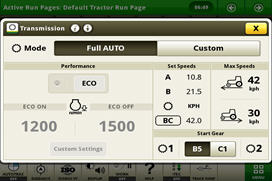 Full auto mode on CommandARM
Full auto mode on CommandARM
CommandCenter setting - custom mode
Overview
Custom mode allows the operator to customize the DirectDrive settings if full auto mode is not desirable.
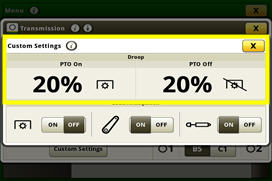 PTO settings
PTO settings
- Eco engine speed
Running under partial load, this setting allows to adjust the minimum engine rpm- Automatic lowering of engine rpm, if possible, under partial load allows to reduce fuel consumption
- Setting between 1800 engine rpm and 1200 engine rpm
- For specific applications (either with PTO or without), engine speed droop can be shut off (eco off)
- For example, driving with a trailer downhill, engine rpm can be reduced
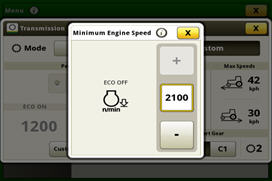 Eco mode off
Eco mode off
 Eco mode on
Eco mode on
- Load anticipation feature can be enabled for:
- Hitch engagement
- Hydraulic engagement
- This feature allows DirectDrive to predict how much load the engine expects from the activation of the hitch or a particular SCV function.
- That is a John Deere only feature.
- Tractor is able to recognize when the additional power is needed on the application and does not forget it.
- Saves fuel because the engine shuts down when no additional power is needed for example during headland turns.
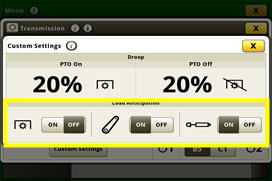 Load anticipation feature
Load anticipation feature
Brake with integrated AutoClutch function
Overview
By depressing both brake pedals simultaneously, the tractor decelerates until it comes to a full stop. No clutching is required. After the brakes are released, the tractor will start to crawl forward.
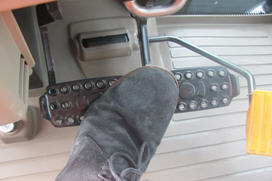 AutoClutch function is integrated – no clutching required
AutoClutch function is integrated – no clutching required
Infinitely Variable Transmission (AutoPowr™/IVT™) system
Overview
The John Deere Infinitely Variable Transmission (AutoPowr/IVT) utilizes a combination of mechanical and hydrostatic power, providing stepless and continuous power across an infinitely variable range of speeds.
Single-speed lever is used for intuitive and accurate control of ground speeds as slow as 50 m/h (0.03 mph) to 40/50 km/h (25/31 mph). In model year 2015, the transmission was revised so transport speeds are reached at lower engine rpms, ultimately reducing fuel consumption and in cab noise. Software has also been revised to ensure under acceleration engine rpm is kept to a minimum within the engines peak torque band.
 AutoPowr/IVT transmission
AutoPowr/IVT transmission
Benefits
- Easy to operate
- Four mechanical modes lead to excellent performance and reduced fuel consumption
- Revised ratios bring transport speeds at reduced engine rpm – reduced fuel consumption and increased comfort
- Precise management of forward speeds
- Less shifting time means better management of the implement
Details
- Requires 240-amp alternator (code 8743) (6110R, 6120R, and 6130R)
- Requires code electrohydraulic (EH) selective control valves (SCVs) and 240-amp alternator
- Requires braked front axle (code 6070)
- Requires hydraulic trailer brakes (code 8756)
- Requires B-speed rated tires and front fenders (8011 or 8012)
NOTE: Not available in 6155RH.
| Code | Description |
| 1552 | AutoPowr/IVT – 50 km/h (31 mph) |
Details
- Requires code EH SCVs
- Requires 240-amp alternator (code 8743) (6110R, 6120R, and 6130R)
NOTE: Not available in 6155RH.
| Code | Description |
| 1551 | AutoPowr/IVT – 40 km/h (25 mph) |
50 km/h (31 mph)
 6R in transport
6R in transport
The following features are part of the 50 km/h (31 mph) package:
- Triple-Link Suspension (TLS™) Plus system with brakes for improved braking capacity
- Rim and tire matching with fixed tread rims to minimize vibration and increase ride comfort
- Trailer brakes
- Front and rear fenders
Set-speed adjusting wheel
Overview
The set-speed adjusting wheel is the rotational thumbwheel located on the speed control lever. The wheel is quick and easy to adjust with the operator’s thumb and rotates infinitely with no stop or start position. When the operator rotates the thumbwheel, the ground speed of the tractor is increased by 0.2 km/h (0.12 mph) when the tractor is traveling below 20 km/h (12 mph). When the tractor is traveling above 20 km/h (12 mph), the tractor is increased by (1) km/h (0.6 mph). The set speed adjuster is used to set the maximum commanded forward or reverse speed in each speed band.
As the operator moves the lever within or between speed bands, the electronic management system ensures smooth, quick, and powerful acceleration or deceleration, regardless of load or ground speed.
While in motion, the operator can adjust the maximum speed of each speed band. With the lever in band one, the target maximum speed can be adjusted to 20 km/h (12 mph). With the lever in band two, the maximum speed of 40/50 km/h (25/31 mph) can be defined depending on transmission option. When stationary, all set speeds, both forward and reverse, may be adjusted while the left-hand reverser is in the power zero position.
 Thumbwheel located on the speed control lever
Thumbwheel located on the speed control lever
 Lever slot between speed brands
Lever slot between speed brands
 Left-hand reverser
Left-hand reverser
For tractors with CommandPRO, the left-hand reverser incorporates only forward and reverse direction selection and the lever is self-centering. The park (P) and neutral (N) positions can be selected on the CommandPRO.
 Full auto screenshot on CommandCenter display
Full auto screenshot on CommandCenter display
Custom mode
Overview
Custom mode allows the operator to customize the AutoPowr/IVT transmission settings when full auto mode is not desirable. In custom mode, operators can turn ECO on and off. This can either be done by pushing the ECO button on the side of the hand throttle module or by selecting ECO in the transmission settings page of the CommandCenter display. When accelerating with ECO on, the tractor minimizes engine speeds, which reduce acceleration aggressiveness. As a result, ECO on should reduce fuel consumption in lighter, steady loads. In contrast, when accelerating with ECO off, engine speed can be higher aggressively to maximize productivity. The higher engine speeds with ECO off better enable the tractor to quickly recover from sudden load increases and not lose as much ground speed when load increases occur.
In custom mode, the engine droop settings can be defined between 4 percent and 30 percent with PTO on and off. The higher the droop percentage, the more the engine rpm will be reduced when pulling before a transmission ratio change is made.
 Drop-down information for set speeds on CommandCenter™ display when rotating the thumbwheel
Drop-down information for set speeds on CommandCenter™ display when rotating the thumbwheel
 Set speed indicated in the dashboard
Set speed indicated in the dashboard
Benefits
- Quick and precise speed changes
- Fine-tuning via the speed wheel
- Two steps in the slot of the speed control lever to program two set speeds
- Speed feedback on the analog dashboard – the needle shows the actual speed, and red lights around the needle show the commanded speed
- Easy-to-handle exact-speed settings through the CommandCenter display and the speed wheel
Left-hand reverser
Overview
An easy-to-use left-hand reverser is available in all the AutoPowr/IVT transmissions. The reverser control is located at the 10 o’clock position on the steering column for intuitive control. For tractors without the CommandPRO™ joystick, the left-hand reverser incorporates the following controls:
- Forward direction selector
- Reverse direction selector
- Park (P) - Park lock (P) - Tractor cannot move and the trailer brakes are engaged. Lever must be in the (P) park position to start the tractor.
- Neutral (N) – Tractor is in a non-parked position and capable of movement.
- Power zero – Tractor is held stationary by the transmission.
 Left-hand reverser if equipped with CommandPRO
Left-hand reverser if equipped with CommandPRO
Benefits
- Tractors without CommandPRO allow for temporary stationary control of the tractor without using the brakes. For tractors with CommandPRO, ActiveZero is always in place when the tractor is not in N or P and brakes are not applied.
- Quick and easy way for the operator to change the direction of the tractor.
- Ensures that the tractor cannot be operated with the park lock on.
Electronic hand and foot throttle
Overview
The tractor ground speed is controlled via the accelerator and hand throttle. The engine rpm can be set to a specific ground speed using the hand throttle (A). The following functions are available for tractors without CommandPRO:
- Button (B) activates and de-activities the FieldCruise™ system (with two available pre-sets), which is an engine rpm limiter.
- The specific ground speed set can be set by pressing button (C); this pedal lock feature works like the cruise control on a car (only functions when foot throttle is ordered).
- Button (D) allows the operator to drive with the minimum target rpm with ECO on.
- NOTE: Button (D) is only active in custom mode.
 Hand throttle
Hand throttle
The following functions are available for tractors with CommandPRO:
- Button (B) and (D) activate and de-activate engine set speeds that can be set in the CommandCenter display.
- Button (C) can be used to fix the engine speed command to the current hand throttle position (no automatic engine speed control).
 Hand throttle when equipped with CommandPRO
Hand throttle when equipped with CommandPRO
 Foot throttle
Foot throttle
Benefits
- Define setting of the engine speed and its limit with the FieldCruise system
- Quick attainment of desired speed
- Pedal lock function allows command foot throttle speed to be maintained
AutoPowr/IVT selector control via CommandCenter display
Overview
The AutoPowr/IVT application setting employs four modes to take full advantage of the engine-transmission communication: full AUTO, custom, pedal and manual.
Full AUTO mode
Overview
Full AUTO mode enables the tractor to make adjustments to the transmission operating mode automatically, based on the engine and transmission speeds and the load on the tractor. This should be the AutoPowr/IVT transmission setting for 95 percent of all applications.
Full AUTO mode switches between load control and fuel economy mode seamlessly, with no involvement from the operator, as conditions and applications change. Fuel economy mode automatically switches off when the power take-off (PTO) is engaged to provide full PTO power. Operators can set the maximum forward and reverse speeds for the tractor in their particular application.
NOTE: Activation ECO is not available in full auto mode.
 Pedal mode display on CommandCenter display
Pedal mode display on CommandCenter display
Benefits
- Pedal mode is ideal for applications like mowing, baling, or hedge cutting, where it is important to keep the engine speed at a constant rpm independent from the ground speed.
Manual mode settings
Overview
Manual mode makes the transmission and engine independent of each other. The transmission does not automatically adjust engine rpm to save fuel. This can prove to be useful in applications like loader work, where the variability of engine speed based on load is not needed.
 Load anticipation display on CommandCenter display
Load anticipation display on CommandCenter display
Benefits
- John Deere exclusive feature
- Tractor recognizes when additional engine rpm is needed
- Saves fuel, because the engine shuts down when no additional power is needed
Forward/Reverse relationship
Overview
Similar to the AutoQuad™ PLUS transmission, the AutoPowr/IVT transmission can also adjust the forward/reverse speed ratio. The reverse speeds can be set to a maximum of 30 percent higher and 70 percent lower than forward speeds, but only in range 1. In range 2, the forward-to-reverse speed ratio is 1:1, up to 22 km/h (14 mph). Above that, the reverse speeds will only go up to 30 km/h (19 mph).
 Section of forward/reverse relationship via CommandCenter display
Section of forward/reverse relationship via CommandCenter display
Brake with integrated AutoClutch function
Overview
With the AutoPowr/IVT transmission, no clutching is required to stop the tractor. After the brakes are released, the tractor automatically accelerates back to its previous speed (if using hand throttle). The effect of AutoClutch can also be set via the CommandCenter display.
 Operator presses brake pedal to stop the tractor
Operator presses brake pedal to stop the tractor
 AutoClutch sensitivity change on CommandCenter display
AutoClutch sensitivity change on CommandCenter display
Benefits
- This feature makes the AutoPowr/IVT an ideal transmission for operations that require a lot of speeds (like baling or loader work).
- Upon release of the AutoClutch, the tractor will accelerate to the previous command speed (ideal for round baling).
- Excellent modulation makes inching to implements and attachments easy.
Torque
Overview
The AutoPowr/IVT transmission is a combination of mechanical and hydraulic components that are capable of providing low speed with extremely high levels of torque:
- Allows the tractor to smoothly pull away, even under high loads
- Enhances front loader operation by delivering high torque, driving the tractor into the pile without slippage
- Retains constant working speeds with PTO implements, which have a tendency to push the tractor (spading or rotary cultivator)
Creeper mode
Creeper mode is a standard feature on the AutoPowr/IVT transmission. Down to 50 m/h (164 ft/h), the creeper mode is activated when the selected speed is below 2.1 km/h (1.3 mph) in set position 1.
When the tractor moves below 600 m/h (1968 ft/h), the engine speed is independent of travel speed. This allows the operator to choose the engine speed that best fits the task (rated speed for hydraulic or PTO usage, or low idle for fuel-saving operation). No additional power is needed.
 Customizing speed of direction on CommandCenter display
Customizing speed of direction on CommandCenter display
 Droop setting on CommandCenter screen
Droop setting on CommandCenter screen
Benefits
- Ensure that the operator has the best driving options when required
- Independent droop settings allow the operator improved performance and flexibility
Pedal mode settings
Overview
Pedal mode allows the operator to change the tractor’s ground speed independently from the engine speed. The ground speed is controlled through use of the foot pedal while the hand throttle determines engine speed. Maximum ground speed is determined by the location of the speed control lever in the speed band. Operators can lock-in a desired ground speed without pressure on the foot pedal using the pedal lock button (as described above). To unlock the foot pedal, the operator can tap the foot pedal, press the lock button, or press the brake pedal. When releasing the foot pedal, the vehicle decelerates to a safe creep speed. To come to a complete stop, the brake pedal should be depressed.
 Manual mode display on CommandCenter display
Manual mode display on CommandCenter display
Load anticipation feature
Overview
The load anticipation feature allows the AutoPowr/IVT transmission to predict how much load the engine expects from the activation of the hitch or a particular SCV function.
In full AUTO mode, all load anticipation features are active. In custom mode, they can be turned on or off in the custom settings page. When an SCV or the hitch is activated, the engine speed is raised to 1500 rpm (as long as the commanded throttle position is over this value). This creates a boost in engine power which improves hydraulic performance and prepares the engine for potential load situations (for example, returning an implement to work). Also added is PTO load anticipation. If it is turned off, the engine does not react to PTO engagement and engine speed is controlled purely based on load. If turned on (in custom), when the PTO is engaged, the engine rpm will rise to throttle position or pre-defined PTO cruise setting.
CommandPRO™ joystick driving strategy
The optional CommandPRO joystick combines a unique driving strategy with reconfigurable controls.
 CommandARM™ controls with CommandPRO
CommandARM™ controls with CommandPRO
Layout and functions
 |
1 – travel set speed buttons 1 and 2 |
 |
4 – reconfigurable buttons and rocker switches (buttons 10 and 11, rocker switches C and D) |
Benefits
- 11 reconfigurable controls for both tractor and implement functions
- Possibility to operate tractor and ISOBUS functions at the same time on the CommandPRO joystick
- Intuitive and easy driving concept
| Code | Description |
| 2089 | Standard Cab with CommandPRO |
| 2091 | Premium Cab with CommandPRO |
| 2092 | Premium Cab with CommandPRO and cab suspension |
Default assignments

| Rocker D: selective control valve (SCV) II (if equipped) | Button 10: engine set speed 1 |
| Rocker C: SCV I (if equipped) | Button 11: engine set speed 2 |
| Rocker B: front hitch (if equipped) | Button 12: AutoTrac™ resume (if equipped) |
| Rocker A: rear hitch (if equipped) |
NOTE: For information about reconfigurability, please see operator's station functional area.
Driving strategy
The unique driving strategy is designed to deliver highest performance in combination with operator comfort making the daily work much easier and efficient.
- Pedal and joystick mode are active at the same time
- ActiveZero keeps the output speed actively at 0 km/h (0 mph) until command for acceleration is given independent of load or engine speed
- Command top and zero speed simply by one push or pull
- Unique inching control
- Three easily adjustable travel set speeds
- Two engine set speeds
- Three acceleration response settings
 Driving strategy
Driving strategy
| Forward movement | Reverse movement | |
| 1 | Accelerate | Decelerate |
| 2 | Top set speed | Zero speed |
| 3 | Decelerate | Accelerate |
| 4 | Zero speed | Accelerate |
| 5 | Activate set speed | |
| 6 | Select direction | |
| 7 | Inching speed | |
| 8 | Inching speed | |
 CommandPRO joystick driving functions
CommandPRO joystick driving functions
Pedal and joystick mode active at the same time
The change between using the foot pedal or the joystick can happen while driving for ease of use and comfort. The simple rule is: the higher speed command is superior. When changing from the pedal to the joystick, there is a short overlap where the joystick takes over the command from the pedal before the pedal is released. Similar, when changing from joystick control to the foot pedal, the driver needs to push the foot pedal to the point of speed where the joystick is before it can take over.
Inching control
The inching control of the CommandPRO joystick simplifies the attachment of implements. Once the joystick is pushed into the inching range, the tractor moves very slowly in the selected direction. Speed is dependent on the joystick position and can be speed between 0 and 2 km/h (0 and 1.2 mph). Maximum speed of the inching range can be set to 5 km/h (3.1 mph) with the travel speed adjustment wheel.
Unlike the main range, releasing the joystick means the speed is reduced until the vehicle stops completely. This allows the operator to fully focus on the implement and quickly stop if required.
 Inching control on CommandPRO joystick
Inching control on CommandPRO joystick
Travel set speeds
The travel set speed buttons on the CommandPRO joystick allow the operator to set two set speeds. The operator has to preselect the desired set speed by pushing the travel set speed button 1 or 2 and once the joystick is pushed to the right, the set speed is activated and the travel speed will be adjusted until the set speed is achieved. Additionally, the operator can set a maximum travel speed through the travel speed adjustment wheel or in the CommandCenter™ display.
There are different ways to set or adjust the set speeds:
- In the CommandCenter display
- If current travel speed should be saved as a set speed, press and hold either one of the buttons for 2 seconds and the speed is saved
- When already using a set speed, it can be adjusted with the travel speed adjustment wheel
The operator can also set a dedicated set speed when changing the travel direction. For example, the tractor is driving forward at 10 km/h (6.2 mph) and for reversing the reverse shuttle shift speed is set to 5 km/h (3.1 mph). This means when the shuttle shift takes place, the tractor will accelerate to 5 km/h (3.1 mph) in reverse direction. This function can be turned on/off and set to the dedicated speed in the CommandCenter display.
 Set speeds and shuttle shift speeds in the CommandCenter
Set speeds and shuttle shift speeds in the CommandCenter
Acceleration response
The three settings for acceleration and deceleration with the CommandPRO joystick can be changed by pressing acceleration response button. Three light-emitting diodes (LEDs) next to the set button indicate the currently activated setting.
- Smooth acceleration and deceleration – one LED glows
- Normal acceleration or deceleration – two LEDs glow
- Rapid acceleration and deceleration – three LEDs glow
 Three settings for acceleration and deceleration
Three settings for acceleration and deceleration
The settings influences the following:
- Characteristics of increase and decrease in speed for both CommandPRO joystick and foot pedal
- Speed change value when flicking the CommandPRO lever forward or backward (triggering).
- 0.2 km/h (0.12 mph) in slow acceleration mode
- 0.5 km/h (0.31 mph) in normal acceleration mode
- 1 km/h (0.62 mph) in rapid acceleration mode
- Acceleration characteristics when activating a travel set speed
- Tractor behavior when commanding a change in direction of travel
To ensure comfortable and reliable deceleration of the tractor with both the foot pedal and the CommandPRO joystick the tractor is equipped with unique technology. The engine overspeed protection ensures that both transmission and engine are not overloaded when decelerating. Additionally, the anti-jackknife technology compares wheel speed of front and rear wheels when decelerating through the joystick, as this means that the front brakes are not applied but only through the rear axle. If the front wheels are moving quicker, the transmission automatically adjusts to ensure the same wheel speed and avoid the jackknife situation.
Park lock and neutral
The park lock is disengaged automatically when commanding any direction of travel. Additionally, it engages automatically when the driver leaves the driver seat while the tractor is stationary. If the tractor is equipped with a trailer brake, this logic also applies for the trailer brake.
The buttons for the park lock and neutral position are next to the CommandPRO joystick on the CommandARM controls. There is no park lock or neutral position available in the left-hand reverser.
 CommandPRO joystick with neutral and park position
CommandPRO joystick with neutral and park position
Rear-mounted selective control valves (SCVs)
Overview
To control a rear implement, up to six SCVs or five SCVs plus Power Beyond can be ordered (6145R-6250R). For (6110R- 6130R) up to five SCVs or four SCVs plus Power Beyond can be ordered. The SCVs can be controlled electrically. Up to four mechanical SCVs are available, in combination with Power Beyond. All mechanical or electrical SCVs feature four positions - neutral, raise, lower, and float.
Benefits
- Release levers make disconnecting hydraulic hoses easy
- Relocated valves improve operator's visibility to the rear hitch
- Up to six rear SCVs give operators total flexibility
| Code | Description | Information | Availability |
| 3312 | Two mechanical SCVs – premium | Premium couplers with high-pressure relief lever. Two mechanical SCVs 450 Series. Only in combination with PowrQuad™ Plus transmission or AutoQuad™ Plus transmission. Only available on 6110R - 6130R. |
6110R, 6120R, 6130R |
| 3332 | Three mechanical SCVs - premium | Premium couplers with high-pressure relief lever. Only in combination with PowrQuad Plus or AutoQuad Plus. | 6110R, 6120R, 6130R, 6145R, 6155R, 6175R, 6195R, 6215R |
| 3311 | Two electronic SCVs - premium | Premium couplers with high-pressure relief lever. | 6110R, 6120R, 6130R |
| 3331 | Three electronic SCVs - premium | Premium couplers with high-pressure relief lever. | 6110R, 6120R, 6130R, 6145R, 6155R, 6175R, 6195R, 6215R, 6230R, 6250R |
| 3341 | Four electronic SCVs - premium | Premium couplers with high-pressure relief lever. | 6110R, 6120R, 6130R, 6145R, 6155R, 6175R, 6195R, 6215R, 6230R, 6250R NOTE: Not available for 6155RH. |
| 3351 | Five electronic SCVs – premium | Premium couplers with high-pressure relief lever. When ordered with right-hand console, (code 2055) also electrical joystick (code 841L) for operation of rear SCVs or electrical midstack SCV (code 8922, 8923, 8914 or 8915) is required. A maximum of four SCVs can be operated via paddle pot at right-hand console. | 6110R, 6120R, 6130R, 6145R, 6155R, 6175R, 6195R, 6215R, 6230R, 6250R NOTE: Not available for 6155RH. |
| 3361 | Six electronic SCVs – premium | Premium couplers with high-pressure relief lever. Not with right-hand console (code 2055). Not in combination with electrical joystick (code 841L) and any option with electrical joystick. | 6145R, 6155R, 6175R, 6195R, 6215R, 6230R, 6250R NOTE: Not available for 6155RH. |
Mechanical control valves
Overview
The tractor may be equipped with one type of mechanical control valves: premium (450 Series).
Premium-couplers control valves also have an additional lock function (position 3), which holds the control lever in the raise or lower position until the pressure in the oil circuit has reached a predetermined value (e.g., when the control cylinder has reached its end position).
In position 2, the control lever returns to neutral as soon as it is released and is the setting for normal hydraulic operation.
If an implement is connected, pressure connection has to be connected to the lower coupler. With standard SCVs, a valve prevents sudden loss of pressure caused by leakage when the engine is shut off.
On premium SCVs, the likelihood of leakage is further diminished.
 Premium mechanical control valve (premium)
Premium mechanical control valve (premium)
- Position 1
- Position 2
- Position 3
- Hydraulic oil flow control
Electrical control valves
Overview
The tractor may be equipped with the premium (450 Series) control valves. All main characteristics can be controlled by the CommandCenter™ display.
 CommandCenter hydraulics option
CommandCenter hydraulics option
Example options of rear valve configuration
 3351 – five electronic SCVs (five SCV premium)
3351 – five electronic SCVs (five SCV premium)
 3361 – six electronic SCVs (six SCV premium)
3361 – six electronic SCVs (six SCV premium)
Hydraulic control options
 E-SCV controls on the right-hand console
E-SCV controls on the right-hand console
 M-SCV controls on the right-hand console
M-SCV controls on the right-hand console
 E- SCV controls on CommandARM™ controls
E- SCV controls on CommandARM™ controls
 E-SCV controls on optional joystick (reconfigurable)
E-SCV controls on optional joystick (reconfigurable)
Hydraulic set up
Shortcut button right-hand console
Overview
Simply push the hydraulic symbol on the right-hand side console or the CommandCenter and the CommandCenter display shows a setup menu to:
- Monitor valve status - detent, float, or neutral
- Adjust maximum flow and detent (combine for both direction or separate extent and retract adjustment)
 Hydraulic shortcut button on right-hand console
Hydraulic shortcut button on right-hand console
 Hydraulic shortcut button CommandCenter
Hydraulic shortcut button CommandCenter
Detent setup
Overview
- Time detent - this is particularly useful when repeat SCV operations are performed, such as lowering a mower-conditioner plow or cycling planter markers.
- Continuous flow detent - this is particularly useful when a hydraulic motor is used, such as on an air seeder.
 Detent setup
Detent setup
SCV flow setup
Overview
SCV flow rate can be programmed between 0.04 and 10 allowing fine tuning for implements with different hydraulic requirement.
Behavior can be set between linear (red), progressive (green), or a combination (yellow) for exact flow modulation and precise valve management.
- Linear means that the distance travelled by the SCV/ICV corresponds to the distance travelled by the control lever/multifunction lever
- Progressive means that initially the distance travelled by the SCV/ICV is less than that travelled by the control lever/multifunction lever (giving a more sensitive start to the movement)
 Flow setup
Flow setup
 Three flow options
Three flow options
 Flow characteristic setup
Flow characteristic setup
Combination is an intermediate stage between the two settings listed above.
ComfortView™ cab operator environment
Overview
ComfortView cabs feature a modern, automotive-style instrument panel as base equipment. The instrument pod has two large analog dials for engine and tractor speed, as well as two smaller dials that display fuel level, diesel exhaust fluid (DEF) level, and coolant temperature. The steering column and dash are adjustable to suit the operator's needs. The column tilts toward the operator and a lever on the left-hand side allows for the column to telescope out to the desired level.
A dimming mode automatically reduces the brightness of the instrument illumination when the tractor lights are used.
Steering column control panel
 Cab and controls of 6R Tractor
Cab and controls of 6R Tractor
 Steering column on 6R Tractor
Steering column on 6R Tractor
Instrumentation control panel
Overview
The instrumentation panel has a row of information and warning lights across the bottom to monitor all important tractor functions. A three-stage warning system first gives information, then gives warnings, and finally, gives a stop alarm to prevent damage from occurring in the event of a component malfunction. An integrated power take-off (PTO) over-speed warning is incorporated into the diagnostics to ensure proper operation.
 Instrumentation control panel
Instrumentation control panel
Dash instrument panel controls include:
| Left side | Right side |
| Left-hand reverser | Two-speed and optional intermittent wiper |
| High-/low-beam switch | Key start/stop |
| Hazard switch | Road/work lights on/off |
| Self-cancelling turn signals/horn |
In-cab storage
 Overhead storage compartment
Overhead storage compartment
 CommandARM™ console storage compartment
CommandARM™ console storage compartment
CommandARM controls
Overview
The 6R Series features a redesigned CommandARM console with all key vehicle functions in one place. The updated CommandARM layout is only available with Infinitely Variable Transmission (IVT™) and DirectDrive transmissions. The base 21.3-cm (8.4-in.) 4200 CommandCenter™ Display or optional 25.4-cm (10-in.) (4600 CommandCenter Display is fully integrated onto the CommandARM and offers fast adjustment of additional tractor functions.
The CommandARM design allows for 37.5 degrees of total seat swivel and adjustable positioning matching the operator’s preference. (30 degrees right and 7.5 degrees left).
Hydraulic and hitch controls utilize fingertip paddle pots for raise/lower and extend/retract functions. The CommandARM offers up to a maximum of six electronic selective control valves (E-SCVs) (without electronic joystick). The optional electrical joystick replaces fingertip paddle pots for control of selective control vales (SCVs) and allows for programmable hydraulic functionality according to operator preference. A maximum of five E-SCVs can be ordered with the electronic joystick. For tractors with an IVT transmission, the CommandPRO™ joystick is available. Its 11 reconfigurable buttons enable the operator to have all necessary controls accessible without hand movements (for details, click here).
Controls for radio, lights, rotary beacon, and hazard flashers are located to the center right on the CommandARM along with PTO for front (if equipped) and rear PTO. Additionally, located on the right side of the CommandARM is an encoder wheel which allows for finite positioning of the rear 3-point hitch. There are three buttons near the encoder for set lock and return to height. Adjustment knobs for the 3-point hitch are located under the cover for the CommandARM storage compartment and allow for adjustment of the rate of drop, hitch height limit, and depth control.
The transmission control and throttle are placed on the left side of the CommandARM closest to the operator for convenient setting and adjustment. The throttle design incorporates buttons which control engine cruise speed, pedal lock/cruise control, and transmission Eco settings (for more information, refer to the AutoPowr™ or DirectDrive transmissions pages).
Located just to the right of the throttle is the auto-steer activation button and four sequence controls for iTEC™ functions. Behind the iTEC sequence controls are buttons which control the activation and deactivation of mechanical front-wheel drive (MFWD) and differential lock.
Differential lock can also be activated by foot switch on the cab floor. A feature in the 6R Series Tractor is auto steering angle dependent differential lock button.
Operators can easily identify controls by icons located near levers, and each functional area is color coded.
Functions:
- Motion (throttle, transmission) - orange
- MFWD and hydraulics (hitch and SCVs) - black
- PTO - yellow
 ComfortView cab with CommandARM console
ComfortView cab with CommandARM console
 Close up of controls on the CommandARM
Close up of controls on the CommandARM
 Optional integrated crossgate joystick
Optional integrated crossgate joystick
 CommandPRO controls (IVT only)
CommandPRO controls (IVT only)
 Hand throttle feature
Hand throttle feature
 3-point hitch control layout
3-point hitch control layout
 Integrated differential lock features
Integrated differential lock features
Benefits
- All main tractor functions in one place
- Hand throttle module with integrated cruise control/pedal lock and Eco function
- Integrated reconfigurable joystick
- All controls and display move with the operator's movement or motion
- Availability of optional 25.4-cm (10-in.) 4600 CommandCenter Display
- Integrated storage compartment with hitch controls
Right-hand console controls
Overview
The right-hand control console is angled for operator comfort and ease of operation. The design of the right-hand console is controlled by the type of SCVs chosen.
Mechanically actuated valves are controlled by traditional levers, while electronically actuated valves are controlled by fingertip paddle pots. Controls for the ComfortView cab are grouped by function on the right-hand console.
The modular console panel provides individual access to hand throttle, transmission controls, MFWD switch (if equipped), hitch command console, load/draft control, SCV, and PTO controls.
The console is also the location of the CommandCenter display. The CommandCenter allows the operator to customize important tractor functions.
This option requires a PowrQuad™ or AutoQuad™ transmission.
 ComfortView cab right-hand console (AutoQuad transmission is shown)
ComfortView cab right-hand console (AutoQuad transmission is shown)
 Hitch control module on right-hand console
Hitch control module on right-hand console
 M-SCV controls on the right-hand console
M-SCV controls on the right-hand console
 E-SCV controls on the right-hand console
E-SCV controls on the right-hand console
Benefits
- Ergonomic placement of controls to match arm movements
- Integrated hitch control module with draft wheel
Cab packages
Overview
The 6R Tractors have seven cab packages designed to match producers' operations. There are three levels of comfort - economy, standard, and premium. There are two control configurations available: a right-hand console for the PowrQuad PLUS or AutoQuad PLUS transmissions and the CommandARM console for the IVT and DirectDrive transmissions. There is an option for hydraulic cab suspension for the premium package. Below is a chart showing the available packages and what is included in each package.
Benefits
- Easy ordering of cab features
- Built-in comfort and convenience
Details
Base features in all cab packages:
- Power outlet
- Seven-pin signal interface socket
- Multi-power outlet strip
- Inner rear view mirror
- Cup holder on rear right-hand cornerpost
- Front wiper and washer
- Overhead compartment with one slot
- Overhead storage compartment on left-hand side
- Courtesy light, coat hook, floor mat
- External starting connectors (outside under right-hand door)
- iTEC control (code 8216)
Cab packages for 6110R, 6120R, 6130R, 6145R, 6155R, 6175R, 6195R, and 6215R
| Cab packages | Economy right-hand console |
Standard right-hand console |
Standard CommandARM |
Premium right-hand console | Premium CommandARM |
Premium right-hand console and cab suspension |
Premium CommandARM and cab suspension |
Standard cab with CommandPRO | Premium cab with CommandPRO | Premium cab with CommandPRO and cab suspension |
| Package code | 2050 | 2057 | 2060 | 2063 | 2064 | 2067 | 2068 | 2089 | 2091 | 2092 |
| Two panorama doors (left-hand and right-hand sides) | X | X | X | X | X | X | X | X | X | X |
| Standard seat (Grammer®) | X | X | X | X | --- | --- | --- | X | --- | --- |
| Premium seat (Grammer DDS) | --- | --- | --- | --- | X | X | X | --- | X | X |
| Instructional seat | X | X | X | X | X | X | X | X | X | X |
| Bottle holder | X | X | X | X | X | X | X | X | X | X |
| Mirrors - right hand and left hand - manually adjustable and telescopic | X | X | X | --- | --- | --- | --- | X | --- | --- |
| Wide-angle mirrors - right hand and left hand - electrically adjustable | --- | --- | --- | X | X | X | X | --- | X | X |
| Front sun visor | X | X | X | --- | --- | --- | --- | X | X | X |
| Front and rear roller blind | --- | --- | --- | X | X | X | X | --- | --- | --- |
| Rear wiper and washer | --- | X | X | X | X | X | X | X | X | X |
| Manual temperature controls | X | X | X | --- | --- | --- | --- | X | X | X |
| Automatic temperature controls | --- | --- | --- | X | X | X | X | --- | X | X |
| Hydraulic cab suspension | --- | --- | --- | --- | --- | X | X | --- | --- | X |
| CommandPro | --- | --- | --- | --- | --- | --- | --- | X | X | X |
| Leather comfort package | --- | --- | --- | --- | --- | X | X | --- | X | X |
*6155RH right-hand console only
Cab packages for 6230R and 6250R
| Cab packages | Standard CommandARM | Premium CommandARM | Premium CommandARM and cab suspension | Standard cab with CommandPRO | Premium cab with CommandPRO | Premium cab with CommandPRO and cab suspension |
| Package code | 2060 | 2064 | 2068 | 2089 | 2091 | 2092 |
| Two panorama doors (left-hand and right-hand sides) | X | X | X | X | X | X |
| Standard seat (Grammer) | X | --- | --- | X | --- | --- |
| Premium seat (Grammer DDS) | --- | X | X | --- | X | X |
| Instructional seat | X | X | X | X | X | X |
| Bottle holder | X | X | X | X | X | X |
| Mirrors - right hand and left hand - manually adjustable and telescopic | X | --- | --- | X | --- | --- |
| Wide-angle mirrors - right hand and left hand - electrically adjustable | --- | X | X | --- | X | X |
| Front sun visor | X | --- | --- | X | X | X |
| Front and rear roller blind | --- | X | X | --- | --- | --- |
| Rear wiper and washer | X | X | X | X | X | X |
| Manual temperature controls | X | --- | --- | X | X | X |
| Automatic temperature controls | --- | X | X | --- | X | X |
| Hydraulic cab suspension | --- | --- | X | --- | --- | X |
| CommandPRO | --- | --- | --- | X | X | X |
| Leather comfort package | --- | X | X | --- | X | X |
Grammer is a trademark of Grammer AG Aktiengesellschaft.
PowerTech™ PVS/PSS Stage 4 engine
Overview
John Deere 6R Series Tractors feature the reliable and proven PowerTech PVS 6.8L and PSS 4.5L and 6.8L engines. These air-to-air aspirated engines deliver a power bulge above rated power to provide excellent torque in demanding applications.
Key features:
- Series turbochargers (PSS only)
- Variable geometry turbocharger (VGT)
- Air-to-air after cooling
- High-pressure common rail (HPCR) fuel system
- Engine control unit (ECU)
PowerTech PSS/PVS engine identification
 |
After treatment
|
Turbocharger
|
|
Technology
|
 PowerTech PSS 6.8L engine
PowerTech PSS 6.8L engine

Benefits
- A constant power range of 2100 rpm down to 1500 rpm
- Power bulge of 10 percent
- Greater tractor productivity
- Responsive power reducing the need to downshift the transmission
Details
To match the engine power characteristics and improve the operation economy of the machine, the rated engine speed is 2100 rpm.
Series turbochargers
Overview
The PowerTech PSS 4.5L and 6.8L utilizes two turbochargers – a VGT and a fixed geometry turbocharger, providing the torque rise and engine response needed to meet varying load conditions.
Fresh air is first drawn into the low-pressure fixed geometry turbocharger and compressed to a higher pressure. The compressed, higher pressure air is then drawn into the high-pressure VGT, where the air is further compressed. By splitting the work between two turbochargers, both can operate at peak efficiency and at slower rotating speeds.
 PowerTech PSS engine series turbochargers
PowerTech PSS engine series turbochargers

Benefits
- Deliver high power density
- More low-speed torque and responsiveness to meet varying load conditions
VGT
Overview
The VGT is electronically controlled and actuates the turbo vanes as required to maintain peak engine performance.
The turbocharger’s vanes are in the exhaust flow. The opening or closing of the vanes changes the outlet volume and airflow speed against the turbocharger turbine. When exhaust flow is low, the vanes are partially closed. This partial closure increases the pressure against the turbine blades to make the turbocharger spin faster and generate more boost pressure.
The ability to keep the airflow at optimum levels provides more consistent engine boost pressure and the ability to respond to load quickly across the entire engine rpm range. This system is without the turbo lag that can be found on some engines.
 High-pressure common rail
High-pressure common rail

Benefits
- Instantly respond to load changes reducing the need to change gears
- Improved fluid economy
Engine control unit (ECU)
Overview
The ECU uses signal inputs from sensors and pre-programmed performance modeling to control critical engine functions such as fuel quantity, injection timing, air-to-fuel ratio, multiple fuel injections, amount of cooled exhaust gas recirculation (EGR), and a host of other control parameters.
 PowerTech VGT
PowerTech VGT

Benefits
- Increased low rpm torque
- Quicker response to load
- Increased peak torque
- Improved fluid economy
- Improved performance at high altitudes
Air-to-air after cooling
Overview
Air-to-air after cooling lowers the intake manifold air temperature and provides more efficient cooling while reducing cylinder firing pressure and temperatures for greater engine reliability. Since lower temperature air is denser, a higher volume of air flows into cylinders so the engine is capable of meeting the increasing horsepower demands. Lowering the intake manifold and cylinder temperatures also aid in lowering the combustion temperature, which lowers the NOx produced as a result.
Benefits
- Higher horsepower
- Less NOx production
HPCR fuel injection system
Overview
Every PowerTech PSS 4.5L and 6.8L engine utilizes a HPCR fuel system to efficiently supply fuel to injectors. The high-pressure fuel pump instantly responds to requirements for more or less fuel flow or pressure. This electronically controlled, high-pressure pump delivers pressure on demand according to the application requirements. Pressure on demand ensures an efficient injection system resulting in high-injection pressure independent of engine speed.
 ECU
ECU

Benefits
- Optimized fluid economy
- Maximum engine performance
Details
Each injector is controlled individually by the ECU. The ECU turns the injector on and off during each firing cycle to control the fuel delivery into each cylinder.
Load and speed sensing allows each cylinder’s fuel delivery rate to be adjusted independently at the individual injector. With each injection cycle, the ECU can make the following adjustments on the go:
- Number of injections
- Fuel pressure in the common rail
- Start of injection
- Duration of injection
This management system is connected to the transmission, allowing the engine and transmission to respond simultaneously.
Cold weather and high-altitude compensation are also precisely controlled for quality starts regardless of weather and maximum performance at high elevations. The ECU also features improved diagnostic capabilities. It is faster, has more working memory, and is responsible for monitoring and executing all aspects of the Integrated Emission Control System.
Lighting options provide maximum visibility in every direction
Overview
Lights on the 6R Series Tractors have been positioned and designed to provide maximum visibility to the front, sides, and rear of the tractor to increase productivity in any operating condition. The cab lighting pattern provides 330 degrees of coverage while the hood lighting provides the remaining 30 degrees for completely programmable, 360-degree, stadium-style lighting.
Base lighting
- Two HB3 hood road lights - low beam (A)
- Two HB3 hood road lights - high beam (B)
- Two HB3 hood outer work lights (C)
- Turn signals beltline mounted with clearance lights (E)
- Turn signals fender mounted (Q)
- Brake lights rear fender mounted (R)
- Two HB3 halogen inner front-roof-mounted adjustable work lights (H) / In an panorama roof the work light represented as (G)
- Two HB3 halogen inner rear-roof-mounted adjustable work lights (N)
Code |
Hood |
Belt |
Front roof |
Side |
Rear roof |
Fender |
|||||||||||
A |
B |
C |
F |
E |
G |
H |
K |
I |
L |
N |
O |
M |
P |
Q |
R |
||
| * Base package - with non-panorama roof | HB3 | HB3 | HB3 | HB3 | HB3 | HB3 | HB3 | HB3 | HB3 | ||||||||
| Light package - Standard | 873F | HB3 | HB3 | HB3 | HB3 | HB3 | LED | X | LED | HB3 | HB3 | HB3 | HB3 | HB3 | HB3 | ||
| Light package - Premium | 873E | HB3 | HB3 | HB3 | HB3 | HB3 | LED | X | LED | HB3 | LED | HB3 | HB3 | HB3 | HB3 | ||
| Light package – Base panorama roof code (878W) | HB3 | HB3 | HB3 | HB3 | HB3 | HB3 | HB3 | HB3 | |||||||||
| Light package - Standard - panorama roof | 873A | HB3 | HB3 | HB3 | HB3 | HB3 | LED | X | HB3 | HB3 | HB3 | ||||||
| Lighting package – Panorama light package | 873C | HB3 | HB3 | HB3 | HB3 | HB3 | LED | X | HB3 | LED | HB3 | HB3 | |||||
 Lighting identification from front view of tractor
Lighting identification from front view of tractor
 Lighting availability on panorama roof
Lighting availability on panorama roof
 Lighting identification from rear view of tractor
Lighting identification from rear view of tractor
Selecting the lighting mode
Overview
Operators can quickly select a lighting mode on the steering console by operating a rotary switch. The four settings available are:
- Light switch in the off position
- Headlights, taillights, and warning lights in the on position
- Headlights in the on position
- Headlights and work lights in the on position (depending on CommandCenter™ assignments)
 Lighting control switch on dashboard
Lighting control switch on dashboard

Benefits
- Easy to locate and operate
- Small and compact design
Programmable lighting
Overview
The CommandCenter allows operators to customize two different light programs. The operator can switch between the two programs with the push button. Also standard on the 6R Tractors is the battery power-saver feature.
When the engine is off and the outside lights have been left on, this feature is designed to avoid battery run-down. After the lights have been left on for 30 minutes and the key is in the off position, the lights will cycle, or blink on and off five times as an alert. The lights will continue to illuminate for one more minute and then automatically shut off to protect the battery.
 CommandCenter programmable time out lighting
CommandCenter programmable time out lighting
 CommandCenter programmable lights page
CommandCenter programmable lights page
 Beacon lights/hazard warning lights, work light 1 and 2 location on right-hand console
Beacon lights/hazard warning lights, work light 1 and 2 location on right-hand console
 Beacon lights/hazard warning lights, work light 1 and 2 location on CommandCenter
Beacon lights/hazard warning lights, work light 1 and 2 location on CommandCenter
Benefits
- The John Deere light programming adds high performance to the operator.
- Individual light selection adds to high operator performance to prevent blinding other operators when two machines are working close to each other.
- Improved uptime due to 360-degree lighting.
Additional lights
Overview
Additional lighting is available to match various applications and ensure maximum around-the-clock productivity. Optional LED lighting technology provides extreme brightness and a daylight color output for excellent definition of the field.
The LED lights provide 40 percent greater coverage width and 10 percent more light coverage in the rear. LED lighting packages use 45 percent less amps than standard halogen lights and have an increased life expectancy over HID lights which leads to lower costs of ownership over the life of the tractor.
Beacon light for added visibility
Overview
One beacon light is mounted on the front of the cab to provide a rotating warning light for road traveling and added visibility.

Benefits
- To warn other road users of the presence of a large machine on the road.
- Easily removed, with no tools required, when approaching height restricted areas.
- Waterproof to ensure good performance when required.
- The beacon has a degree of flexible movement, and are not completely static, and can withstand the impact of objects such as tree branches.
Details
- Front cab is roof mounted.
- A second beacon light can be field installed on the right side of the cab roof.
Triple-Link Suspension (TLS™) Plus: More than comfort, it is a performance feature
More productivity - greater operator's comfort
CommandCenter™ console TLS Plus provides exclusive front suspension using a hydropneumatic self-leveling system to increase productivity and improve ride dramatically. TLS Plus provides more control over the front suspension of the tractor. In the field, the TLS Plus front suspension maintains ground-to-tire contact, enabling more power to the ground.
 Front axle adjustment on CommandCenter
Front axle adjustment on CommandCenter
Auto mode
The TLS Plus reacts to inputs, which provides the best comfort and stability. Inputs include travel speed, implement weight, draft characteristics, and braking activity. The TLS Plus activates whenever the tractor exceeds 1.5 km/h (0.9 mph).
Maximum mode
The suspension is set to maximum hardness, which is preferable for front loader operation. This allows the operator to adjust the suspension for different situations. If the tractor exceeds 35 km/h (22 mph), the hardness is reduced to provide greater driving comfort. When dropping below 25 km/h (15 mph), maximum is reactivated.
Manual mode
This setting can be useful when attaching mounted implements to the front hitch. When activated, the axle settles in its mid position and then can be raised or lowered manually with the touchscreen or shortcut buttons F and G. The manual setting is overridden when the travel speed exceeds 5 km/h (3 mph) and returns to the previously selected setting of automatic or maximum.
The system
|
First link: vertical linkage Two double-acting hydraulic cylinders control the vertical movement of the axle, which leads to excellent sensitivity. |
|
Second link: longitudinal linkage |
|
Third link: lateral linkage This third link holds the axle laterally. These few simple components ensure excellent suspension quality and reliability with reduced maintenance. |
A full stroke of the suspension typically takes 1 second, allowing the system time to distinguish between typical terrain inputs or level changes. This prevents overreactions.
In addition to active central leveling of the suspension, the John Deere TLS Plus adopts a constantly variable rod side pressure by using a closed loop system. When the suspension reacts at a different frequency, which could be detrimental to driver comfort, the system then fine-tunes the rod side pressure, changing the spring stiffness and improving the ride behavior.
*Not available in 6155RH
ISOBUS and tractor-baler automation offer new baling experience
Tractor-Baler Automation simplifies baling experience
 A single manual action; system manages the rest
A single manual action; system manages the rest
 TBA awards
TBA awards
The optional Tractor-Baler Automation (TBA) makes baling easy. This exclusive system manages most of the baling process and gives the customer the following advantages:
- High baling comfort a single action to bale instead of four.
- Error proof baling - even after 10 working hours, the system does not forget any action; a true advantage for an inexperienced driver.
- Constant bale quality - same diameter bale after bale
- Constant productivity - no reduced efficiency due to operators fatigue.
When used with a John Deere ISOBUS tractor, electric selective control valve (E-SCV), and (IVT™) transmission, the system will be able to:
- Stop the tractor when bale size is reached
- Wrap the bale
- Open the gate
- Close the gate when bale is unloaded
The only action remaining is to forward reverser and manage the steering.
If the John Deere tractor is not equipped with IVT but has E-SCV and ISOBUS, opening and closing can be automated.
A single touch on SCV, brakes, or reverser will disengage the automation. In the same way, automated open/close can be momentarily stopped when unloading in hilly conditions.
Tractor-Implement Automation is an exclusive green on green advantage. This advanced technology option has won awards at SIMA and Agritechnica farm equipment show in Europe, a true cost/value guarantee.
NOTE: to run through fully automated mode, a John Deere Isobus tractor with E-SCV and IVT is required. A baler activation key and a tractor activation key (different) have to be ordered.
ISOBUS certified balers
 Plug in and bale with ISOBUS
Plug in and bale with ISOBUS
 ISOBUS certified = compatibility guarantee
ISOBUS certified = compatibility guarantee
The 990 and 960 Balers offer ISOBUS compatibility as base equipment. This standardized communication not only allows the use of John Deere Greenstar2 1800, 2600, or 2630 Displays, but also the use of other ISOBUS conform competitive monitors.
Adapter harnesses for non-ISOBUS tractors are available.
User friendly interface
 Main page with simple and clear pictograms
Main page with simple and clear pictograms
 Bale or soft core density adjustments
Bale or soft core density adjustments
The Baler interface displays information that is needed. The 900 Series monitors provide all required information:
- Bale shape and diameter
- Drop floor and knives position
- Variable core activation
- Tying process status
- Gate position
- Maintenance status
Adjustments can also be managed from the operators station:
- Bale size and density
- Variable core diameter and density
- Net and twine tying parameters
- Knife selection
- Automated lubrication
- Tractor-Baler Automation status
- Bale counter resets
Greenstar™2 1800 has the ideal display for baling application
 Greenstar2 1800 Display ordered with the baler
Greenstar2 1800 Display ordered with the baler

The 900 Series Balers can be teamed with all ISOBUS certified displays. The Greenstar2 1800 monitor can be ordered with the baler to match traditional baling requirements. When not baling this display can be used for other functions such as guidance and spraying applications when connected to an appropriate receiver and implement.
All ISOBUS display will fit the 900 Series
 GreenStar3 2630 fits the most demanding user needs
GreenStar3 2630 fits the most demanding user needs

The 960 and 990 Balers can be ordered without a monitor for customers who already have an ISOBUS display, or for those who search more advanced application (field management). Displays other than John Deere Greenstar2 1800 can be purchased through Ag Management Solutions (AMS) pages.
Features
CommandCenter™ display
Overview
The Generation 4 CommandCenter creates the primary user interface for 6R Series Tractors. The Generation 4 CommandCenter provides an excellent, user-savvy operating experience.
Producers can also use a variety of implements with the Generation 4 CommandCenter as it is ISOBUS virtual terminal (VT) capable.
Expect machine productivity gains, along with increased operator confidence, thanks to a simple, customizable interface. The reliability of the Generation 4 CommandCenter also aids in optimal operating experience and maximizes uptime.
 4200 CommandCenter 21.3-cm (8.4-in.) display
4200 CommandCenter 21.3-cm (8.4-in.) display
 4600 CommandCenter 25.4-cm (10-in.) display
4600 CommandCenter 25.4-cm (10-in.) display
Benefits
- Easy-to-change fields and guidance lines
- Custom-defined views
- On-screen help functions
- Intelligent warnings
- Context-based help
Details
| Code | Description |
| 1947 | 4200 Processor (21.3-cm [8.4-in.] display only) |
| 1946 | 4600 Processor (25.4-cm [10-in.] display only) |
| Code | Description |
| 1829 | 21.3-cm (8.4-in.) CommandCenter display (4200 Processor only) |
| 1822 | 25.4-cm (10-in.) CommandCenter display (4600 Processor only) |
| Code | Description |
| 1867 | Less application |
| 1851 | CommandCenter AutoTrac™ activation |
| 1858 | 4200 Section Control and Data Sync activation plus CommandCenter AutoTrac activation |
| 1857 | 4600 CommandCenter Premium Activation 3.0 |
| 1861 | 4600 CommandCenter Automation Activation 1.0 |
| 186S | 4600 CommandCenter Automation Activation 3.0 |
NOTE: CommandCenter AutoTrac activation stays with the tractor.
NOTE: 6155RH only available with code 1867.
 Help center main page
Help center main page
Additionally, application-based help is also available in all locations of the CommandCenter. Simply click on the (i) icon available on the title bar and it will lead directly to more information on the application currently being used.
Display options
Generation 4 CommandCenter displays are available in the following configurations:
- 21.3-cm (8.4-in.) display on the 4200 CommandCenter
- 25.4-cm (10-in.) display on the 4600 CommandCenter
For those wanting to maximize their viewing real estate, the 25.4-cm (10-in.) touchscreen color display is an excellent choice. With the 25.4-cm (10-in.) display, the title bar and all shortcut keys may be viewed at all times. Operators can monitor more items at once on the 25.4-cm (10-in.) touchscreen display.
Layout Manager
 Layout Manager selection page
Layout Manager selection page
 Layout Manager module build
Layout Manager module build
The Generation 4 CommandCenter features a modular-designed layout manager so an operator can easily create the structure that meets the operator’s demands. From the factory, machines are equipped with standard run pages. An unlimited amount of run pages can be added to the Generation 4 CommandCenter based on operator preference or operational needs. Toggling between run pages is as easy as swiping the screen or using the arrow buttons on the top right portion of the title bar.
Users and access
Users and access allow the owner to lock out certain functions to prevent operators from accessing or changing settings. Lock-out functions are managed with an owner-defined four-digit code.
Lockout features are available for:
- Precision Ag Technology applications
- Hitch
- Hydraulic
- Transmission
- Power take-off (PTO)
- FieldCruise™ engine controls
- Display
- Machine monitor
On-screen help and diagnostic text
There are a number of different ways to get meaningful on-screen help when navigating the Generation 4 CommandCenter. Operators can find the help icon on the shortcut bar on the bottom of every page. This icon gives detailed information on everything from tractor operation to application information. Simply select the help icon and navigate to the information section that is needed.
Work monitor
 Work monitor page
Work monitor page
The work monitor application displays the performance information about the task being performed by the machine. The user is shown averages, totals, and productivity of the machine, such as area worked, average working speed, and fuel usage. The values of the work monitor can be reset by the user at any time. Specific values of the work monitor can be configured by the user to be shown on a run page.
NOTE: The work monitor application replaces part of the universal performance monitor in previous machines.
Video capability
Tractors with a 4200 CommandCenter are equipped with one video input and tractors with a 4600 CommandCenter have two video inputs. The operator has the ability to set a variety of triggers, including reverse, PTO, hitch, and selective control valve (SCV) levers to activate the camera. The image will then appear on the CommandCenter display. The camera (video observation system) is available through JD Parts and Ag and Industrial (A & I) Products.
John Deere Generation 4 CommandCenter processors
A Generation 4 CommandCenter is made up of a processor and a display. Two processor options are available for the Generation 4 CommandCenter.
The 4600 Processor is the premium processor. Available features with the premium processor include:
- Compatible with 25.4-cm (10-in.) touchscreen display
- Two video camera inputs
- One USB input
- AutoTrac capable (machine-specific activation sold separately)
 Context-based help iTEC™ main page
Context-based help iTEC™ main page
Diagnostic text and information is available for better understanding of whether applications are operating as directed.
Machine monitor
 Machine monitor page
Machine monitor page
The machine monitor application provides the user instantaneous readings about the status or condition of the machine. Values shown in the machine monitor vary by application, but typically include parameters like engine speed, coolant temperature, and ground speed. The machine monitor supports run page modules in the layout manager, allowing the user to populate specific machine parameters directly to a run page.
NOTE: The machine monitor application replaces part of the Universal Performance Monitor in previous machines.
 25.4-cm (10-in.) 4600 CommandCenter display
25.4-cm (10-in.) 4600 CommandCenter display
The 4200 Processor is base equipment on all 6R Tractors. It offers:
- Compatible with 21.3-cm (8.4-in.) touchscreen display
- One video camera input
- One USB input
- AutoTrac capable (machine-specific activation sold separately)
| Tractors | 4600 Processor | 4200 Processor |
| 6R | Option | Standard |
 John Deere 4200 CommandCenter
John Deere 4200 CommandCenter
A. Next run page
B. Status center
C. Expand shortcut keys
D. Menu
E. Run page
 John Deere 4600 CommandCenter
John Deere 4600 CommandCenter
A. Next and previous run page
B. Status center
C. Shortcut keys
D. Menu
E. Run page
F. Title bar
DirectDrive
Overview
The DirectDrive transmission combines the efficiency benefits of a manual shift transmission with easy handling similar to the AutoPowr™/IVT™ transmission. DirectDrive utilizes unique double-clutch technology giving 6R operators more driving comfort.
Since this is a mechanical transmission, it provides smooth shifting between gears with high efficiency. Smooth shifting is achieved by excellent modulation between the dual clutches in combination with engine rpm management to speed match the next gear.
DirectDrive uses efficiency manager to automatically change up gears and throttle back, similar to how AutoPowr varies its ratio to achieve minimum engine rpm with a higher transmission ratio.
 The best of both worlds - efficiency and comfort
The best of both worlds - efficiency and comfort
Benefits
- Excellent mechanical power transfer
- Double-clutch technology (unique to PowerShift™ transmissions)
- Ranges perfectly fitted to agricultural applications – less need of range shifts
- Very good reduction in engine rpm at 40 km/h (25 mph). An operator concept that allows transmission control similar to an infinitely variable transmission.
- AutoClutch™ function
- Three set speeds and cruise control button
Details
| Code | Description | Available for | Information |
| 1530 | DirectDrive – 40 km/h (25 mph) | 6175R, 6195R, 6215R | Double clutch transmission, 40 km/h (25 mph) at reduced engine speed |
The modular concept
The DirectDrive transmission consists of the range box, the dual-path module, and the PowrReverser™.
Range box
The range box in the 6R Series consists of three ranges perfectly suited for agricultural applications.
- Range A: 2.7 km/h to 10.8 km/h (1.6 mph to 6.7 mph)
- Range B: 5.4 km/h to 22 km/h (3.3 mph to 13.6 mph)
- Range C: 13 km/h to 40 km/h (8 mph to 25 mph) at 1550 rpm
Changing from ranges is quick and simple and due to its adaptation to agricultural applications, it is hardly ever required in the field. Less range shifting means fewer torque interruptions.
 40 km/h (25 mph) during transportation
40 km/h (25 mph) during transportation
Ideal ranges for all needs (40 km/h [25 mph] version)
![Ideal ranges for all needs (40 km/h [25 mph] version)](https://salesmanual.deere.com/sales/salesmanual/images/NA/tractors/6r/range_40.jpg) Ideal ranges for all needs (40 km/h [25 mph] version)
Ideal ranges for all needs (40 km/h [25 mph] version)
Dual-path module
Overview
The dual path module includes the eight PowerShift gears, available in all three ranges. The PowerShift gears can change automatically, creating a very efficient drive strategy to save fuel and reduce noise.
The main technical innovation is the use of two clutches in one transmission. This system allows very fast shifting between gears and is highly efficient. The second gear is already lined up, ready to go, and just waiting for the change command to be given.
 Dual-path module PowerShift gears
Dual-path module PowerShift gears
Left-hand reverser
Overview
An easy-to-use left-hand reverser is available in all the DirectDrive transmissions. The reverser control is located at the 10 o’clock position on the steering column for intuitive control. The left-hand reverser incorporates the following controls:
- Forward direction selector
- Reverse direction selector
- Park (P) – park lock (P) - tractor cannot move and the trailer brakes are engaged. Lever must be in the (P) park position to start the tractor.
- Neutral (N) - tractor is in a non-parked position and capable of movement.
 Left-hand reverser
Left-hand reverser
Benefits
- Quick and easy way for the operator to make powered changes in the direction of the tractor.
- Ensures that the tractor cannot be operated with the park brake engaged.
Electronic hand and foot throttle
Overview
The tractor ground speed is controlled via the accelerator and hand throttle. The engine rpm can be set to a specific ground speed using the hand throttle (A). Button (B) activates and de-activates FieldCruise™ (with two available pre-sets), which is an engine rpm limiter. The specific ground speed can be set by pressing button (C), this pedal lock feature works like the cruise control on a car. Button (D) allows the operator to drive with the minimum target rpm with eco on; note button (D) is only active in custom mode.
 Hand throttle
Hand throttle
 Foot throttle
Foot throttle
Benefits
- Pedal lock function allows command foot throttle speed to be maintained
- Define setting of the engine speed and its limit with FieldCruise
- Quick attainment of desired speed
Gear and range views in display
Overview
In the DirectDrive transmission, the selected range and selected PowerShift gear can be viewed in the dashboard.
Similar to the AutoPowr/IVT transmission control and display, the DirectDrive transmission has the red lights inside the speed display so the operator can see how fast the tractor will go at full commanded speed. This is adjusted using the speed wheel on top of the shift control lever.
 Ranges A, B, C, and PowerShift steps are displayed on the dashboard
Ranges A, B, C, and PowerShift steps are displayed on the dashboard
 Set speed indicated in the dashboard
Set speed indicated in the dashboard
Cab ComfortView™ Premium Plus – CommandARM™
Overview
The DirectDrive transmission can only be equipped on the CommandARM.
 DirectDrive control unit
DirectDrive control unit
 Custom mode settings on CommandARM
Custom mode settings on CommandARM
- Auto shift engine speed droop
If the tractor runs under full load, the gear shifting can be customized with this setting.
In custom mode the engine droop settings can be defined between 6 percent and 40 percent with power take-off (PTO) on and off. The higher the droop percentage, the more the engine rpm will be reduced when pulling before a transmission down shift is made.
A speed droop expressed as percentage of full engine speed can be chosen:
- Between 6 percent and 40 percent with PTO off
- Between 20 percent and 40 percent with PTO on
 Control unit integrated into CommandARM
Control unit integrated into CommandARM
DirectDrive control unit
Overview
The DirectDrive control unit consists of the speed control lever, which has an ergonomically integrated set speed adjusting wheel. The set speed adjusting wheel is a rotational thumbwheel located on the speed control lever. The wheel is quick and easy to adjust with the thumb and rotates infinitely with no stop or start position. When the operator rotates the thumbwheel, the maximum commanded forward/reverse speed is set. Also integrated are three buttons to set the ranges.
- Range buttons
- Quick and precise speed changes with the A, B, B/C- range shift buttons
- Selection depends on the work to be done
- Range A: Heavy draft work
- Range B: Secondary tillage, mowing
- Range B/C: Transport (includes automatic range shift from range B to C)
- Speed lever
- Ergonomically integrated speed wheel to infinitely adjust the speed
- Two-function slot to set the eight PowerShift gears; auto mode and manual mode
- Easily change between modes using only the speed lever, without using the clutch
 Thumbwheel located on the speed control lever
Thumbwheel located on the speed control lever
Manual mode
Overview
In this mode, the operator manually changes the gears. Put the lever up (+) to select a higher gear and put the lever down (-) to select a lower gear. In this mode the throttle and transmission are independent, efficiency manager is only effective in auto mode.
 DirectDrive speed lever in manual mode
DirectDrive speed lever in manual mode
Full auto mode
Overview
If the lever is put in the right position, the auto mode is selected and the transmission shifts automatically, depending on the engine load and speed.
 DirectDrive speed lever in full auto mode
DirectDrive speed lever in full auto mode
CommandCenter™ settings – Full auto mode
Overview
Full auto mode enables the tractor to make adjustments to the transmission operating mode automatically, based on the engine and transmission speeds and the load on the tractor.
Full auto mode switches between load control and fuel economy mode seamlessly, with no involvement from the operator, as conditions and applications change. Fuel economy mode automatically switches off when the PTO is engaged to provide full PTO power. Operators can set the maximum forward and reverse speeds for the tractor in their particular applications.
 Full auto mode on CommandARM
Full auto mode on CommandARM
CommandCenter setting - custom mode
Overview
Custom mode allows the operator to customize the DirectDrive settings if full auto mode is not desirable.
 PTO settings
PTO settings
- Eco engine speed
Running under partial load, this setting allows to adjust the minimum engine rpm- Automatic lowering of engine rpm, if possible, under partial load allows to reduce fuel consumption
- Setting between 1800 engine rpm and 1200 engine rpm
- For specific applications (either with PTO or without), engine speed droop can be shut off (eco off)
- For example, driving with a trailer downhill, engine rpm can be reduced
 Eco mode off
Eco mode off
 Eco mode on
Eco mode on
- Load anticipation feature can be enabled for:
- Hitch engagement
- Hydraulic engagement
- This feature allows DirectDrive to predict how much load the engine expects from the activation of the hitch or a particular SCV function.
- That is a John Deere only feature.
- Tractor is able to recognize when the additional power is needed on the application and does not forget it.
- Saves fuel because the engine shuts down when no additional power is needed for example during headland turns.
 Load anticipation feature
Load anticipation feature
Brake with integrated AutoClutch function
Overview
By depressing both brake pedals simultaneously, the tractor decelerates until it comes to a full stop. No clutching is required. After the brakes are released, the tractor will start to crawl forward.
 AutoClutch function is integrated – no clutching required
AutoClutch function is integrated – no clutching required
Infinitely Variable Transmission (AutoPowr™/IVT™) system
Overview
The John Deere Infinitely Variable Transmission (AutoPowr/IVT) utilizes a combination of mechanical and hydrostatic power, providing stepless and continuous power across an infinitely variable range of speeds.
Single-speed lever is used for intuitive and accurate control of ground speeds as slow as 50 m/h (0.03 mph) to 40/50 km/h (25/31 mph). In model year 2015, the transmission was revised so transport speeds are reached at lower engine rpms, ultimately reducing fuel consumption and in cab noise. Software has also been revised to ensure under acceleration engine rpm is kept to a minimum within the engines peak torque band.
 AutoPowr/IVT transmission
AutoPowr/IVT transmission
Benefits
- Easy to operate
- Four mechanical modes lead to excellent performance and reduced fuel consumption
- Revised ratios bring transport speeds at reduced engine rpm – reduced fuel consumption and increased comfort
- Precise management of forward speeds
- Less shifting time means better management of the implement
Details
- Requires 240-amp alternator (code 8743) (6110R, 6120R, and 6130R)
- Requires code electrohydraulic (EH) selective control valves (SCVs) and 240-amp alternator
- Requires braked front axle (code 6070)
- Requires hydraulic trailer brakes (code 8756)
- Requires B-speed rated tires and front fenders (8011 or 8012)
NOTE: Not available in 6155RH.
| Code | Description |
| 1552 | AutoPowr/IVT – 50 km/h (31 mph) |
Details
- Requires code EH SCVs
- Requires 240-amp alternator (code 8743) (6110R, 6120R, and 6130R)
NOTE: Not available in 6155RH.
| Code | Description |
| 1551 | AutoPowr/IVT – 40 km/h (25 mph) |
50 km/h (31 mph)
 6R in transport
6R in transport
The following features are part of the 50 km/h (31 mph) package:
- Triple-Link Suspension (TLS™) Plus system with brakes for improved braking capacity
- Rim and tire matching with fixed tread rims to minimize vibration and increase ride comfort
- Trailer brakes
- Front and rear fenders
Set-speed adjusting wheel
Overview
The set-speed adjusting wheel is the rotational thumbwheel located on the speed control lever. The wheel is quick and easy to adjust with the operator’s thumb and rotates infinitely with no stop or start position. When the operator rotates the thumbwheel, the ground speed of the tractor is increased by 0.2 km/h (0.12 mph) when the tractor is traveling below 20 km/h (12 mph). When the tractor is traveling above 20 km/h (12 mph), the tractor is increased by (1) km/h (0.6 mph). The set speed adjuster is used to set the maximum commanded forward or reverse speed in each speed band.
As the operator moves the lever within or between speed bands, the electronic management system ensures smooth, quick, and powerful acceleration or deceleration, regardless of load or ground speed.
While in motion, the operator can adjust the maximum speed of each speed band. With the lever in band one, the target maximum speed can be adjusted to 20 km/h (12 mph). With the lever in band two, the maximum speed of 40/50 km/h (25/31 mph) can be defined depending on transmission option. When stationary, all set speeds, both forward and reverse, may be adjusted while the left-hand reverser is in the power zero position.
 Thumbwheel located on the speed control lever
Thumbwheel located on the speed control lever
 Lever slot between speed brands
Lever slot between speed brands
 Left-hand reverser
Left-hand reverser
For tractors with CommandPRO, the left-hand reverser incorporates only forward and reverse direction selection and the lever is self-centering. The park (P) and neutral (N) positions can be selected on the CommandPRO.
 Full auto screenshot on CommandCenter display
Full auto screenshot on CommandCenter display
Custom mode
Overview
Custom mode allows the operator to customize the AutoPowr/IVT transmission settings when full auto mode is not desirable. In custom mode, operators can turn ECO on and off. This can either be done by pushing the ECO button on the side of the hand throttle module or by selecting ECO in the transmission settings page of the CommandCenter display. When accelerating with ECO on, the tractor minimizes engine speeds, which reduce acceleration aggressiveness. As a result, ECO on should reduce fuel consumption in lighter, steady loads. In contrast, when accelerating with ECO off, engine speed can be higher aggressively to maximize productivity. The higher engine speeds with ECO off better enable the tractor to quickly recover from sudden load increases and not lose as much ground speed when load increases occur.
In custom mode, the engine droop settings can be defined between 4 percent and 30 percent with PTO on and off. The higher the droop percentage, the more the engine rpm will be reduced when pulling before a transmission ratio change is made.
 Drop-down information for set speeds on CommandCenter™ display when rotating the thumbwheel
Drop-down information for set speeds on CommandCenter™ display when rotating the thumbwheel
 Set speed indicated in the dashboard
Set speed indicated in the dashboard
Benefits
- Quick and precise speed changes
- Fine-tuning via the speed wheel
- Two steps in the slot of the speed control lever to program two set speeds
- Speed feedback on the analog dashboard – the needle shows the actual speed, and red lights around the needle show the commanded speed
- Easy-to-handle exact-speed settings through the CommandCenter display and the speed wheel
Left-hand reverser
Overview
An easy-to-use left-hand reverser is available in all the AutoPowr/IVT transmissions. The reverser control is located at the 10 o’clock position on the steering column for intuitive control. For tractors without the CommandPRO™ joystick, the left-hand reverser incorporates the following controls:
- Forward direction selector
- Reverse direction selector
- Park (P) - Park lock (P) - Tractor cannot move and the trailer brakes are engaged. Lever must be in the (P) park position to start the tractor.
- Neutral (N) – Tractor is in a non-parked position and capable of movement.
- Power zero – Tractor is held stationary by the transmission.
 Left-hand reverser if equipped with CommandPRO
Left-hand reverser if equipped with CommandPRO
Benefits
- Tractors without CommandPRO allow for temporary stationary control of the tractor without using the brakes. For tractors with CommandPRO, ActiveZero is always in place when the tractor is not in N or P and brakes are not applied.
- Quick and easy way for the operator to change the direction of the tractor.
- Ensures that the tractor cannot be operated with the park lock on.
Electronic hand and foot throttle
Overview
The tractor ground speed is controlled via the accelerator and hand throttle. The engine rpm can be set to a specific ground speed using the hand throttle (A). The following functions are available for tractors without CommandPRO:
- Button (B) activates and de-activities the FieldCruise™ system (with two available pre-sets), which is an engine rpm limiter.
- The specific ground speed set can be set by pressing button (C); this pedal lock feature works like the cruise control on a car (only functions when foot throttle is ordered).
- Button (D) allows the operator to drive with the minimum target rpm with ECO on.
- NOTE: Button (D) is only active in custom mode.
 Hand throttle
Hand throttle
The following functions are available for tractors with CommandPRO:
- Button (B) and (D) activate and de-activate engine set speeds that can be set in the CommandCenter display.
- Button (C) can be used to fix the engine speed command to the current hand throttle position (no automatic engine speed control).
 Hand throttle when equipped with CommandPRO
Hand throttle when equipped with CommandPRO
 Foot throttle
Foot throttle
Benefits
- Define setting of the engine speed and its limit with the FieldCruise system
- Quick attainment of desired speed
- Pedal lock function allows command foot throttle speed to be maintained
AutoPowr/IVT selector control via CommandCenter display
Overview
The AutoPowr/IVT application setting employs four modes to take full advantage of the engine-transmission communication: full AUTO, custom, pedal and manual.
Full AUTO mode
Overview
Full AUTO mode enables the tractor to make adjustments to the transmission operating mode automatically, based on the engine and transmission speeds and the load on the tractor. This should be the AutoPowr/IVT transmission setting for 95 percent of all applications.
Full AUTO mode switches between load control and fuel economy mode seamlessly, with no involvement from the operator, as conditions and applications change. Fuel economy mode automatically switches off when the power take-off (PTO) is engaged to provide full PTO power. Operators can set the maximum forward and reverse speeds for the tractor in their particular application.
NOTE: Activation ECO is not available in full auto mode.
 Pedal mode display on CommandCenter display
Pedal mode display on CommandCenter display
Benefits
- Pedal mode is ideal for applications like mowing, baling, or hedge cutting, where it is important to keep the engine speed at a constant rpm independent from the ground speed.
Manual mode settings
Overview
Manual mode makes the transmission and engine independent of each other. The transmission does not automatically adjust engine rpm to save fuel. This can prove to be useful in applications like loader work, where the variability of engine speed based on load is not needed.
 Load anticipation display on CommandCenter display
Load anticipation display on CommandCenter display
Benefits
- John Deere exclusive feature
- Tractor recognizes when additional engine rpm is needed
- Saves fuel, because the engine shuts down when no additional power is needed
Forward/Reverse relationship
Overview
Similar to the AutoQuad™ PLUS transmission, the AutoPowr/IVT transmission can also adjust the forward/reverse speed ratio. The reverse speeds can be set to a maximum of 30 percent higher and 70 percent lower than forward speeds, but only in range 1. In range 2, the forward-to-reverse speed ratio is 1:1, up to 22 km/h (14 mph). Above that, the reverse speeds will only go up to 30 km/h (19 mph).
 Section of forward/reverse relationship via CommandCenter display
Section of forward/reverse relationship via CommandCenter display
Brake with integrated AutoClutch function
Overview
With the AutoPowr/IVT transmission, no clutching is required to stop the tractor. After the brakes are released, the tractor automatically accelerates back to its previous speed (if using hand throttle). The effect of AutoClutch can also be set via the CommandCenter display.
 Operator presses brake pedal to stop the tractor
Operator presses brake pedal to stop the tractor
 AutoClutch sensitivity change on CommandCenter display
AutoClutch sensitivity change on CommandCenter display
Benefits
- This feature makes the AutoPowr/IVT an ideal transmission for operations that require a lot of speeds (like baling or loader work).
- Upon release of the AutoClutch, the tractor will accelerate to the previous command speed (ideal for round baling).
- Excellent modulation makes inching to implements and attachments easy.
Torque
Overview
The AutoPowr/IVT transmission is a combination of mechanical and hydraulic components that are capable of providing low speed with extremely high levels of torque:
- Allows the tractor to smoothly pull away, even under high loads
- Enhances front loader operation by delivering high torque, driving the tractor into the pile without slippage
- Retains constant working speeds with PTO implements, which have a tendency to push the tractor (spading or rotary cultivator)
Creeper mode
Creeper mode is a standard feature on the AutoPowr/IVT transmission. Down to 50 m/h (164 ft/h), the creeper mode is activated when the selected speed is below 2.1 km/h (1.3 mph) in set position 1.
When the tractor moves below 600 m/h (1968 ft/h), the engine speed is independent of travel speed. This allows the operator to choose the engine speed that best fits the task (rated speed for hydraulic or PTO usage, or low idle for fuel-saving operation). No additional power is needed.
 Customizing speed of direction on CommandCenter display
Customizing speed of direction on CommandCenter display
 Droop setting on CommandCenter screen
Droop setting on CommandCenter screen
Benefits
- Ensure that the operator has the best driving options when required
- Independent droop settings allow the operator improved performance and flexibility
Pedal mode settings
Overview
Pedal mode allows the operator to change the tractor’s ground speed independently from the engine speed. The ground speed is controlled through use of the foot pedal while the hand throttle determines engine speed. Maximum ground speed is determined by the location of the speed control lever in the speed band. Operators can lock-in a desired ground speed without pressure on the foot pedal using the pedal lock button (as described above). To unlock the foot pedal, the operator can tap the foot pedal, press the lock button, or press the brake pedal. When releasing the foot pedal, the vehicle decelerates to a safe creep speed. To come to a complete stop, the brake pedal should be depressed.
 Manual mode display on CommandCenter display
Manual mode display on CommandCenter display
Load anticipation feature
Overview
The load anticipation feature allows the AutoPowr/IVT transmission to predict how much load the engine expects from the activation of the hitch or a particular SCV function.
In full AUTO mode, all load anticipation features are active. In custom mode, they can be turned on or off in the custom settings page. When an SCV or the hitch is activated, the engine speed is raised to 1500 rpm (as long as the commanded throttle position is over this value). This creates a boost in engine power which improves hydraulic performance and prepares the engine for potential load situations (for example, returning an implement to work). Also added is PTO load anticipation. If it is turned off, the engine does not react to PTO engagement and engine speed is controlled purely based on load. If turned on (in custom), when the PTO is engaged, the engine rpm will rise to throttle position or pre-defined PTO cruise setting.
CommandPRO™ joystick driving strategy
The optional CommandPRO joystick combines a unique driving strategy with reconfigurable controls.
 CommandARM™ controls with CommandPRO
CommandARM™ controls with CommandPRO
Layout and functions
 |
1 – travel set speed buttons 1 and 2 |
 |
4 – reconfigurable buttons and rocker switches (buttons 10 and 11, rocker switches C and D) |
Benefits
- 11 reconfigurable controls for both tractor and implement functions
- Possibility to operate tractor and ISOBUS functions at the same time on the CommandPRO joystick
- Intuitive and easy driving concept
| Code | Description |
| 2089 | Standard Cab with CommandPRO |
| 2091 | Premium Cab with CommandPRO |
| 2092 | Premium Cab with CommandPRO and cab suspension |
Default assignments

| Rocker D: selective control valve (SCV) II (if equipped) | Button 10: engine set speed 1 |
| Rocker C: SCV I (if equipped) | Button 11: engine set speed 2 |
| Rocker B: front hitch (if equipped) | Button 12: AutoTrac™ resume (if equipped) |
| Rocker A: rear hitch (if equipped) |
NOTE: For information about reconfigurability, please see operator's station functional area.
Driving strategy
The unique driving strategy is designed to deliver highest performance in combination with operator comfort making the daily work much easier and efficient.
- Pedal and joystick mode are active at the same time
- ActiveZero keeps the output speed actively at 0 km/h (0 mph) until command for acceleration is given independent of load or engine speed
- Command top and zero speed simply by one push or pull
- Unique inching control
- Three easily adjustable travel set speeds
- Two engine set speeds
- Three acceleration response settings
 Driving strategy
Driving strategy
| Forward movement | Reverse movement | |
| 1 | Accelerate | Decelerate |
| 2 | Top set speed | Zero speed |
| 3 | Decelerate | Accelerate |
| 4 | Zero speed | Accelerate |
| 5 | Activate set speed | |
| 6 | Select direction | |
| 7 | Inching speed | |
| 8 | Inching speed | |
 CommandPRO joystick driving functions
CommandPRO joystick driving functions
Pedal and joystick mode active at the same time
The change between using the foot pedal or the joystick can happen while driving for ease of use and comfort. The simple rule is: the higher speed command is superior. When changing from the pedal to the joystick, there is a short overlap where the joystick takes over the command from the pedal before the pedal is released. Similar, when changing from joystick control to the foot pedal, the driver needs to push the foot pedal to the point of speed where the joystick is before it can take over.
Inching control
The inching control of the CommandPRO joystick simplifies the attachment of implements. Once the joystick is pushed into the inching range, the tractor moves very slowly in the selected direction. Speed is dependent on the joystick position and can be speed between 0 and 2 km/h (0 and 1.2 mph). Maximum speed of the inching range can be set to 5 km/h (3.1 mph) with the travel speed adjustment wheel.
Unlike the main range, releasing the joystick means the speed is reduced until the vehicle stops completely. This allows the operator to fully focus on the implement and quickly stop if required.
 Inching control on CommandPRO joystick
Inching control on CommandPRO joystick
Travel set speeds
The travel set speed buttons on the CommandPRO joystick allow the operator to set two set speeds. The operator has to preselect the desired set speed by pushing the travel set speed button 1 or 2 and once the joystick is pushed to the right, the set speed is activated and the travel speed will be adjusted until the set speed is achieved. Additionally, the operator can set a maximum travel speed through the travel speed adjustment wheel or in the CommandCenter™ display.
There are different ways to set or adjust the set speeds:
- In the CommandCenter display
- If current travel speed should be saved as a set speed, press and hold either one of the buttons for 2 seconds and the speed is saved
- When already using a set speed, it can be adjusted with the travel speed adjustment wheel
The operator can also set a dedicated set speed when changing the travel direction. For example, the tractor is driving forward at 10 km/h (6.2 mph) and for reversing the reverse shuttle shift speed is set to 5 km/h (3.1 mph). This means when the shuttle shift takes place, the tractor will accelerate to 5 km/h (3.1 mph) in reverse direction. This function can be turned on/off and set to the dedicated speed in the CommandCenter display.
 Set speeds and shuttle shift speeds in the CommandCenter
Set speeds and shuttle shift speeds in the CommandCenter
Acceleration response
The three settings for acceleration and deceleration with the CommandPRO joystick can be changed by pressing acceleration response button. Three light-emitting diodes (LEDs) next to the set button indicate the currently activated setting.
- Smooth acceleration and deceleration – one LED glows
- Normal acceleration or deceleration – two LEDs glow
- Rapid acceleration and deceleration – three LEDs glow
 Three settings for acceleration and deceleration
Three settings for acceleration and deceleration
The settings influences the following:
- Characteristics of increase and decrease in speed for both CommandPRO joystick and foot pedal
- Speed change value when flicking the CommandPRO lever forward or backward (triggering).
- 0.2 km/h (0.12 mph) in slow acceleration mode
- 0.5 km/h (0.31 mph) in normal acceleration mode
- 1 km/h (0.62 mph) in rapid acceleration mode
- Acceleration characteristics when activating a travel set speed
- Tractor behavior when commanding a change in direction of travel
To ensure comfortable and reliable deceleration of the tractor with both the foot pedal and the CommandPRO joystick the tractor is equipped with unique technology. The engine overspeed protection ensures that both transmission and engine are not overloaded when decelerating. Additionally, the anti-jackknife technology compares wheel speed of front and rear wheels when decelerating through the joystick, as this means that the front brakes are not applied but only through the rear axle. If the front wheels are moving quicker, the transmission automatically adjusts to ensure the same wheel speed and avoid the jackknife situation.
Park lock and neutral
The park lock is disengaged automatically when commanding any direction of travel. Additionally, it engages automatically when the driver leaves the driver seat while the tractor is stationary. If the tractor is equipped with a trailer brake, this logic also applies for the trailer brake.
The buttons for the park lock and neutral position are next to the CommandPRO joystick on the CommandARM controls. There is no park lock or neutral position available in the left-hand reverser.
 CommandPRO joystick with neutral and park position
CommandPRO joystick with neutral and park position
Rear-mounted selective control valves (SCVs)
Overview
To control a rear implement, up to six SCVs or five SCVs plus Power Beyond can be ordered (6145R-6250R). For (6110R- 6130R) up to five SCVs or four SCVs plus Power Beyond can be ordered. The SCVs can be controlled electrically. Up to four mechanical SCVs are available, in combination with Power Beyond. All mechanical or electrical SCVs feature four positions - neutral, raise, lower, and float.
Benefits
- Release levers make disconnecting hydraulic hoses easy
- Relocated valves improve operator's visibility to the rear hitch
- Up to six rear SCVs give operators total flexibility
| Code | Description | Information | Availability |
| 3312 | Two mechanical SCVs – premium | Premium couplers with high-pressure relief lever. Two mechanical SCVs 450 Series. Only in combination with PowrQuad™ Plus transmission or AutoQuad™ Plus transmission. Only available on 6110R - 6130R. |
6110R, 6120R, 6130R |
| 3332 | Three mechanical SCVs - premium | Premium couplers with high-pressure relief lever. Only in combination with PowrQuad Plus or AutoQuad Plus. | 6110R, 6120R, 6130R, 6145R, 6155R, 6175R, 6195R, 6215R |
| 3311 | Two electronic SCVs - premium | Premium couplers with high-pressure relief lever. | 6110R, 6120R, 6130R |
| 3331 | Three electronic SCVs - premium | Premium couplers with high-pressure relief lever. | 6110R, 6120R, 6130R, 6145R, 6155R, 6175R, 6195R, 6215R, 6230R, 6250R |
| 3341 | Four electronic SCVs - premium | Premium couplers with high-pressure relief lever. | 6110R, 6120R, 6130R, 6145R, 6155R, 6175R, 6195R, 6215R, 6230R, 6250R NOTE: Not available for 6155RH. |
| 3351 | Five electronic SCVs – premium | Premium couplers with high-pressure relief lever. When ordered with right-hand console, (code 2055) also electrical joystick (code 841L) for operation of rear SCVs or electrical midstack SCV (code 8922, 8923, 8914 or 8915) is required. A maximum of four SCVs can be operated via paddle pot at right-hand console. | 6110R, 6120R, 6130R, 6145R, 6155R, 6175R, 6195R, 6215R, 6230R, 6250R NOTE: Not available for 6155RH. |
| 3361 | Six electronic SCVs – premium | Premium couplers with high-pressure relief lever. Not with right-hand console (code 2055). Not in combination with electrical joystick (code 841L) and any option with electrical joystick. | 6145R, 6155R, 6175R, 6195R, 6215R, 6230R, 6250R NOTE: Not available for 6155RH. |
Mechanical control valves
Overview
The tractor may be equipped with one type of mechanical control valves: premium (450 Series).
Premium-couplers control valves also have an additional lock function (position 3), which holds the control lever in the raise or lower position until the pressure in the oil circuit has reached a predetermined value (e.g., when the control cylinder has reached its end position).
In position 2, the control lever returns to neutral as soon as it is released and is the setting for normal hydraulic operation.
If an implement is connected, pressure connection has to be connected to the lower coupler. With standard SCVs, a valve prevents sudden loss of pressure caused by leakage when the engine is shut off.
On premium SCVs, the likelihood of leakage is further diminished.
 Premium mechanical control valve (premium)
Premium mechanical control valve (premium)
- Position 1
- Position 2
- Position 3
- Hydraulic oil flow control
Electrical control valves
Overview
The tractor may be equipped with the premium (450 Series) control valves. All main characteristics can be controlled by the CommandCenter™ display.
 CommandCenter hydraulics option
CommandCenter hydraulics option
Example options of rear valve configuration
 3351 – five electronic SCVs (five SCV premium)
3351 – five electronic SCVs (five SCV premium)
 3361 – six electronic SCVs (six SCV premium)
3361 – six electronic SCVs (six SCV premium)
Hydraulic control options
 E-SCV controls on the right-hand console
E-SCV controls on the right-hand console
 M-SCV controls on the right-hand console
M-SCV controls on the right-hand console
 E- SCV controls on CommandARM™ controls
E- SCV controls on CommandARM™ controls
 E-SCV controls on optional joystick (reconfigurable)
E-SCV controls on optional joystick (reconfigurable)
Hydraulic set up
Shortcut button right-hand console
Overview
Simply push the hydraulic symbol on the right-hand side console or the CommandCenter and the CommandCenter display shows a setup menu to:
- Monitor valve status - detent, float, or neutral
- Adjust maximum flow and detent (combine for both direction or separate extent and retract adjustment)
 Hydraulic shortcut button on right-hand console
Hydraulic shortcut button on right-hand console
 Hydraulic shortcut button CommandCenter
Hydraulic shortcut button CommandCenter
Detent setup
Overview
- Time detent - this is particularly useful when repeat SCV operations are performed, such as lowering a mower-conditioner plow or cycling planter markers.
- Continuous flow detent - this is particularly useful when a hydraulic motor is used, such as on an air seeder.
 Detent setup
Detent setup
SCV flow setup
Overview
SCV flow rate can be programmed between 0.04 and 10 allowing fine tuning for implements with different hydraulic requirement.
Behavior can be set between linear (red), progressive (green), or a combination (yellow) for exact flow modulation and precise valve management.
- Linear means that the distance travelled by the SCV/ICV corresponds to the distance travelled by the control lever/multifunction lever
- Progressive means that initially the distance travelled by the SCV/ICV is less than that travelled by the control lever/multifunction lever (giving a more sensitive start to the movement)
 Flow setup
Flow setup
 Three flow options
Three flow options
 Flow characteristic setup
Flow characteristic setup
Combination is an intermediate stage between the two settings listed above.
ComfortView™ cab operator environment
Overview
ComfortView cabs feature a modern, automotive-style instrument panel as base equipment. The instrument pod has two large analog dials for engine and tractor speed, as well as two smaller dials that display fuel level, diesel exhaust fluid (DEF) level, and coolant temperature. The steering column and dash are adjustable to suit the operator's needs. The column tilts toward the operator and a lever on the left-hand side allows for the column to telescope out to the desired level.
A dimming mode automatically reduces the brightness of the instrument illumination when the tractor lights are used.
Steering column control panel
 Cab and controls of 6R Tractor
Cab and controls of 6R Tractor
 Steering column on 6R Tractor
Steering column on 6R Tractor
Instrumentation control panel
Overview
The instrumentation panel has a row of information and warning lights across the bottom to monitor all important tractor functions. A three-stage warning system first gives information, then gives warnings, and finally, gives a stop alarm to prevent damage from occurring in the event of a component malfunction. An integrated power take-off (PTO) over-speed warning is incorporated into the diagnostics to ensure proper operation.
 Instrumentation control panel
Instrumentation control panel
Dash instrument panel controls include:
| Left side | Right side |
| Left-hand reverser | Two-speed and optional intermittent wiper |
| High-/low-beam switch | Key start/stop |
| Hazard switch | Road/work lights on/off |
| Self-cancelling turn signals/horn |
In-cab storage
 Overhead storage compartment
Overhead storage compartment
 CommandARM™ console storage compartment
CommandARM™ console storage compartment
CommandARM controls
Overview
The 6R Series features a redesigned CommandARM console with all key vehicle functions in one place. The updated CommandARM layout is only available with Infinitely Variable Transmission (IVT™) and DirectDrive transmissions. The base 21.3-cm (8.4-in.) 4200 CommandCenter™ Display or optional 25.4-cm (10-in.) (4600 CommandCenter Display is fully integrated onto the CommandARM and offers fast adjustment of additional tractor functions.
The CommandARM design allows for 37.5 degrees of total seat swivel and adjustable positioning matching the operator’s preference. (30 degrees right and 7.5 degrees left).
Hydraulic and hitch controls utilize fingertip paddle pots for raise/lower and extend/retract functions. The CommandARM offers up to a maximum of six electronic selective control valves (E-SCVs) (without electronic joystick). The optional electrical joystick replaces fingertip paddle pots for control of selective control vales (SCVs) and allows for programmable hydraulic functionality according to operator preference. A maximum of five E-SCVs can be ordered with the electronic joystick. For tractors with an IVT transmission, the CommandPRO™ joystick is available. Its 11 reconfigurable buttons enable the operator to have all necessary controls accessible without hand movements (for details, click here).
Controls for radio, lights, rotary beacon, and hazard flashers are located to the center right on the CommandARM along with PTO for front (if equipped) and rear PTO. Additionally, located on the right side of the CommandARM is an encoder wheel which allows for finite positioning of the rear 3-point hitch. There are three buttons near the encoder for set lock and return to height. Adjustment knobs for the 3-point hitch are located under the cover for the CommandARM storage compartment and allow for adjustment of the rate of drop, hitch height limit, and depth control.
The transmission control and throttle are placed on the left side of the CommandARM closest to the operator for convenient setting and adjustment. The throttle design incorporates buttons which control engine cruise speed, pedal lock/cruise control, and transmission Eco settings (for more information, refer to the AutoPowr™ or DirectDrive transmissions pages).
Located just to the right of the throttle is the auto-steer activation button and four sequence controls for iTEC™ functions. Behind the iTEC sequence controls are buttons which control the activation and deactivation of mechanical front-wheel drive (MFWD) and differential lock.
Differential lock can also be activated by foot switch on the cab floor. A feature in the 6R Series Tractor is auto steering angle dependent differential lock button.
Operators can easily identify controls by icons located near levers, and each functional area is color coded.
Functions:
- Motion (throttle, transmission) - orange
- MFWD and hydraulics (hitch and SCVs) - black
- PTO - yellow
 ComfortView cab with CommandARM console
ComfortView cab with CommandARM console
 Close up of controls on the CommandARM
Close up of controls on the CommandARM
 Optional integrated crossgate joystick
Optional integrated crossgate joystick
 CommandPRO controls (IVT only)
CommandPRO controls (IVT only)
 Hand throttle feature
Hand throttle feature
 3-point hitch control layout
3-point hitch control layout
 Integrated differential lock features
Integrated differential lock features
Benefits
- All main tractor functions in one place
- Hand throttle module with integrated cruise control/pedal lock and Eco function
- Integrated reconfigurable joystick
- All controls and display move with the operator's movement or motion
- Availability of optional 25.4-cm (10-in.) 4600 CommandCenter Display
- Integrated storage compartment with hitch controls
Right-hand console controls
Overview
The right-hand control console is angled for operator comfort and ease of operation. The design of the right-hand console is controlled by the type of SCVs chosen.
Mechanically actuated valves are controlled by traditional levers, while electronically actuated valves are controlled by fingertip paddle pots. Controls for the ComfortView cab are grouped by function on the right-hand console.
The modular console panel provides individual access to hand throttle, transmission controls, MFWD switch (if equipped), hitch command console, load/draft control, SCV, and PTO controls.
The console is also the location of the CommandCenter display. The CommandCenter allows the operator to customize important tractor functions.
This option requires a PowrQuad™ or AutoQuad™ transmission.
 ComfortView cab right-hand console (AutoQuad transmission is shown)
ComfortView cab right-hand console (AutoQuad transmission is shown)
 Hitch control module on right-hand console
Hitch control module on right-hand console
 M-SCV controls on the right-hand console
M-SCV controls on the right-hand console
 E-SCV controls on the right-hand console
E-SCV controls on the right-hand console
Benefits
- Ergonomic placement of controls to match arm movements
- Integrated hitch control module with draft wheel
Cab packages
Overview
The 6R Tractors have seven cab packages designed to match producers' operations. There are three levels of comfort - economy, standard, and premium. There are two control configurations available: a right-hand console for the PowrQuad PLUS or AutoQuad PLUS transmissions and the CommandARM console for the IVT and DirectDrive transmissions. There is an option for hydraulic cab suspension for the premium package. Below is a chart showing the available packages and what is included in each package.
Benefits
- Easy ordering of cab features
- Built-in comfort and convenience
Details
Base features in all cab packages:
- Power outlet
- Seven-pin signal interface socket
- Multi-power outlet strip
- Inner rear view mirror
- Cup holder on rear right-hand cornerpost
- Front wiper and washer
- Overhead compartment with one slot
- Overhead storage compartment on left-hand side
- Courtesy light, coat hook, floor mat
- External starting connectors (outside under right-hand door)
- iTEC control (code 8216)
Cab packages for 6110R, 6120R, 6130R, 6145R, 6155R, 6175R, 6195R, and 6215R
| Cab packages | Economy right-hand console |
Standard right-hand console |
Standard CommandARM |
Premium right-hand console | Premium CommandARM |
Premium right-hand console and cab suspension |
Premium CommandARM and cab suspension |
Standard cab with CommandPRO | Premium cab with CommandPRO | Premium cab with CommandPRO and cab suspension |
| Package code | 2050 | 2057 | 2060 | 2063 | 2064 | 2067 | 2068 | 2089 | 2091 | 2092 |
| Two panorama doors (left-hand and right-hand sides) | X | X | X | X | X | X | X | X | X | X |
| Standard seat (Grammer®) | X | X | X | X | --- | --- | --- | X | --- | --- |
| Premium seat (Grammer DDS) | --- | --- | --- | --- | X | X | X | --- | X | X |
| Instructional seat | X | X | X | X | X | X | X | X | X | X |
| Bottle holder | X | X | X | X | X | X | X | X | X | X |
| Mirrors - right hand and left hand - manually adjustable and telescopic | X | X | X | --- | --- | --- | --- | X | --- | --- |
| Wide-angle mirrors - right hand and left hand - electrically adjustable | --- | --- | --- | X | X | X | X | --- | X | X |
| Front sun visor | X | X | X | --- | --- | --- | --- | X | X | X |
| Front and rear roller blind | --- | --- | --- | X | X | X | X | --- | --- | --- |
| Rear wiper and washer | --- | X | X | X | X | X | X | X | X | X |
| Manual temperature controls | X | X | X | --- | --- | --- | --- | X | X | X |
| Automatic temperature controls | --- | --- | --- | X | X | X | X | --- | X | X |
| Hydraulic cab suspension | --- | --- | --- | --- | --- | X | X | --- | --- | X |
| CommandPro | --- | --- | --- | --- | --- | --- | --- | X | X | X |
| Leather comfort package | --- | --- | --- | --- | --- | X | X | --- | X | X |
*6155RH right-hand console only
Cab packages for 6230R and 6250R
| Cab packages | Standard CommandARM | Premium CommandARM | Premium CommandARM and cab suspension | Standard cab with CommandPRO | Premium cab with CommandPRO | Premium cab with CommandPRO and cab suspension |
| Package code | 2060 | 2064 | 2068 | 2089 | 2091 | 2092 |
| Two panorama doors (left-hand and right-hand sides) | X | X | X | X | X | X |
| Standard seat (Grammer) | X | --- | --- | X | --- | --- |
| Premium seat (Grammer DDS) | --- | X | X | --- | X | X |
| Instructional seat | X | X | X | X | X | X |
| Bottle holder | X | X | X | X | X | X |
| Mirrors - right hand and left hand - manually adjustable and telescopic | X | --- | --- | X | --- | --- |
| Wide-angle mirrors - right hand and left hand - electrically adjustable | --- | X | X | --- | X | X |
| Front sun visor | X | --- | --- | X | X | X |
| Front and rear roller blind | --- | X | X | --- | --- | --- |
| Rear wiper and washer | X | X | X | X | X | X |
| Manual temperature controls | X | --- | --- | X | X | X |
| Automatic temperature controls | --- | X | X | --- | X | X |
| Hydraulic cab suspension | --- | --- | X | --- | --- | X |
| CommandPRO | --- | --- | --- | X | X | X |
| Leather comfort package | --- | X | X | --- | X | X |
Grammer is a trademark of Grammer AG Aktiengesellschaft.
PowerTech™ PVS/PSS Stage 4 engine
Overview
John Deere 6R Series Tractors feature the reliable and proven PowerTech PVS 6.8L and PSS 4.5L and 6.8L engines. These air-to-air aspirated engines deliver a power bulge above rated power to provide excellent torque in demanding applications.
Key features:
- Series turbochargers (PSS only)
- Variable geometry turbocharger (VGT)
- Air-to-air after cooling
- High-pressure common rail (HPCR) fuel system
- Engine control unit (ECU)
PowerTech PSS/PVS engine identification
 |
After treatment
|
Turbocharger
|
|
Technology
|
 PowerTech PSS 6.8L engine
PowerTech PSS 6.8L engine

Benefits
- A constant power range of 2100 rpm down to 1500 rpm
- Power bulge of 10 percent
- Greater tractor productivity
- Responsive power reducing the need to downshift the transmission
Details
To match the engine power characteristics and improve the operation economy of the machine, the rated engine speed is 2100 rpm.
Series turbochargers
Overview
The PowerTech PSS 4.5L and 6.8L utilizes two turbochargers – a VGT and a fixed geometry turbocharger, providing the torque rise and engine response needed to meet varying load conditions.
Fresh air is first drawn into the low-pressure fixed geometry turbocharger and compressed to a higher pressure. The compressed, higher pressure air is then drawn into the high-pressure VGT, where the air is further compressed. By splitting the work between two turbochargers, both can operate at peak efficiency and at slower rotating speeds.
 PowerTech PSS engine series turbochargers
PowerTech PSS engine series turbochargers

Benefits
- Deliver high power density
- More low-speed torque and responsiveness to meet varying load conditions
VGT
Overview
The VGT is electronically controlled and actuates the turbo vanes as required to maintain peak engine performance.
The turbocharger’s vanes are in the exhaust flow. The opening or closing of the vanes changes the outlet volume and airflow speed against the turbocharger turbine. When exhaust flow is low, the vanes are partially closed. This partial closure increases the pressure against the turbine blades to make the turbocharger spin faster and generate more boost pressure.
The ability to keep the airflow at optimum levels provides more consistent engine boost pressure and the ability to respond to load quickly across the entire engine rpm range. This system is without the turbo lag that can be found on some engines.
 High-pressure common rail
High-pressure common rail

Benefits
- Instantly respond to load changes reducing the need to change gears
- Improved fluid economy
Engine control unit (ECU)
Overview
The ECU uses signal inputs from sensors and pre-programmed performance modeling to control critical engine functions such as fuel quantity, injection timing, air-to-fuel ratio, multiple fuel injections, amount of cooled exhaust gas recirculation (EGR), and a host of other control parameters.
 PowerTech VGT
PowerTech VGT

Benefits
- Increased low rpm torque
- Quicker response to load
- Increased peak torque
- Improved fluid economy
- Improved performance at high altitudes
Air-to-air after cooling
Overview
Air-to-air after cooling lowers the intake manifold air temperature and provides more efficient cooling while reducing cylinder firing pressure and temperatures for greater engine reliability. Since lower temperature air is denser, a higher volume of air flows into cylinders so the engine is capable of meeting the increasing horsepower demands. Lowering the intake manifold and cylinder temperatures also aid in lowering the combustion temperature, which lowers the NOx produced as a result.
Benefits
- Higher horsepower
- Less NOx production
HPCR fuel injection system
Overview
Every PowerTech PSS 4.5L and 6.8L engine utilizes a HPCR fuel system to efficiently supply fuel to injectors. The high-pressure fuel pump instantly responds to requirements for more or less fuel flow or pressure. This electronically controlled, high-pressure pump delivers pressure on demand according to the application requirements. Pressure on demand ensures an efficient injection system resulting in high-injection pressure independent of engine speed.
 ECU
ECU

Benefits
- Optimized fluid economy
- Maximum engine performance
Details
Each injector is controlled individually by the ECU. The ECU turns the injector on and off during each firing cycle to control the fuel delivery into each cylinder.
Load and speed sensing allows each cylinder’s fuel delivery rate to be adjusted independently at the individual injector. With each injection cycle, the ECU can make the following adjustments on the go:
- Number of injections
- Fuel pressure in the common rail
- Start of injection
- Duration of injection
This management system is connected to the transmission, allowing the engine and transmission to respond simultaneously.
Cold weather and high-altitude compensation are also precisely controlled for quality starts regardless of weather and maximum performance at high elevations. The ECU also features improved diagnostic capabilities. It is faster, has more working memory, and is responsible for monitoring and executing all aspects of the Integrated Emission Control System.
Lighting options provide maximum visibility in every direction
Overview
Lights on the 6R Series Tractors have been positioned and designed to provide maximum visibility to the front, sides, and rear of the tractor to increase productivity in any operating condition. The cab lighting pattern provides 330 degrees of coverage while the hood lighting provides the remaining 30 degrees for completely programmable, 360-degree, stadium-style lighting.
Base lighting
- Two HB3 hood road lights - low beam (A)
- Two HB3 hood road lights - high beam (B)
- Two HB3 hood outer work lights (C)
- Turn signals beltline mounted with clearance lights (E)
- Turn signals fender mounted (Q)
- Brake lights rear fender mounted (R)
- Two HB3 halogen inner front-roof-mounted adjustable work lights (H) / In an panorama roof the work light represented as (G)
- Two HB3 halogen inner rear-roof-mounted adjustable work lights (N)
Code |
Hood |
Belt |
Front roof |
Side |
Rear roof |
Fender |
|||||||||||
A |
B |
C |
F |
E |
G |
H |
K |
I |
L |
N |
O |
M |
P |
Q |
R |
||
| * Base package - with non-panorama roof | HB3 | HB3 | HB3 | HB3 | HB3 | HB3 | HB3 | HB3 | HB3 | ||||||||
| Light package - Standard | 873F | HB3 | HB3 | HB3 | HB3 | HB3 | LED | X | LED | HB3 | HB3 | HB3 | HB3 | HB3 | HB3 | ||
| Light package - Premium | 873E | HB3 | HB3 | HB3 | HB3 | HB3 | LED | X | LED | HB3 | LED | HB3 | HB3 | HB3 | HB3 | ||
| Light package – Base panorama roof code (878W) | HB3 | HB3 | HB3 | HB3 | HB3 | HB3 | HB3 | HB3 | |||||||||
| Light package - Standard - panorama roof | 873A | HB3 | HB3 | HB3 | HB3 | HB3 | LED | X | HB3 | HB3 | HB3 | ||||||
| Lighting package – Panorama light package | 873C | HB3 | HB3 | HB3 | HB3 | HB3 | LED | X | HB3 | LED | HB3 | HB3 | |||||
 Lighting identification from front view of tractor
Lighting identification from front view of tractor
 Lighting availability on panorama roof
Lighting availability on panorama roof
 Lighting identification from rear view of tractor
Lighting identification from rear view of tractor
Selecting the lighting mode
Overview
Operators can quickly select a lighting mode on the steering console by operating a rotary switch. The four settings available are:
- Light switch in the off position
- Headlights, taillights, and warning lights in the on position
- Headlights in the on position
- Headlights and work lights in the on position (depending on CommandCenter™ assignments)
 Lighting control switch on dashboard
Lighting control switch on dashboard

Benefits
- Easy to locate and operate
- Small and compact design
Programmable lighting
Overview
The CommandCenter allows operators to customize two different light programs. The operator can switch between the two programs with the push button. Also standard on the 6R Tractors is the battery power-saver feature.
When the engine is off and the outside lights have been left on, this feature is designed to avoid battery run-down. After the lights have been left on for 30 minutes and the key is in the off position, the lights will cycle, or blink on and off five times as an alert. The lights will continue to illuminate for one more minute and then automatically shut off to protect the battery.
 CommandCenter programmable time out lighting
CommandCenter programmable time out lighting
 CommandCenter programmable lights page
CommandCenter programmable lights page
 Beacon lights/hazard warning lights, work light 1 and 2 location on right-hand console
Beacon lights/hazard warning lights, work light 1 and 2 location on right-hand console
 Beacon lights/hazard warning lights, work light 1 and 2 location on CommandCenter
Beacon lights/hazard warning lights, work light 1 and 2 location on CommandCenter
Benefits
- The John Deere light programming adds high performance to the operator.
- Individual light selection adds to high operator performance to prevent blinding other operators when two machines are working close to each other.
- Improved uptime due to 360-degree lighting.
Additional lights
Overview
Additional lighting is available to match various applications and ensure maximum around-the-clock productivity. Optional LED lighting technology provides extreme brightness and a daylight color output for excellent definition of the field.
The LED lights provide 40 percent greater coverage width and 10 percent more light coverage in the rear. LED lighting packages use 45 percent less amps than standard halogen lights and have an increased life expectancy over HID lights which leads to lower costs of ownership over the life of the tractor.
Beacon light for added visibility
Overview
One beacon light is mounted on the front of the cab to provide a rotating warning light for road traveling and added visibility.

Benefits
- To warn other road users of the presence of a large machine on the road.
- Easily removed, with no tools required, when approaching height restricted areas.
- Waterproof to ensure good performance when required.
- The beacon has a degree of flexible movement, and are not completely static, and can withstand the impact of objects such as tree branches.
Details
- Front cab is roof mounted.
- A second beacon light can be field installed on the right side of the cab roof.
Triple-Link Suspension (TLS™) Plus: More than comfort, it is a performance feature
More productivity - greater operator's comfort
CommandCenter™ console TLS Plus provides exclusive front suspension using a hydropneumatic self-leveling system to increase productivity and improve ride dramatically. TLS Plus provides more control over the front suspension of the tractor. In the field, the TLS Plus front suspension maintains ground-to-tire contact, enabling more power to the ground.
 Front axle adjustment on CommandCenter
Front axle adjustment on CommandCenter
Auto mode
The TLS Plus reacts to inputs, which provides the best comfort and stability. Inputs include travel speed, implement weight, draft characteristics, and braking activity. The TLS Plus activates whenever the tractor exceeds 1.5 km/h (0.9 mph).
Maximum mode
The suspension is set to maximum hardness, which is preferable for front loader operation. This allows the operator to adjust the suspension for different situations. If the tractor exceeds 35 km/h (22 mph), the hardness is reduced to provide greater driving comfort. When dropping below 25 km/h (15 mph), maximum is reactivated.
Manual mode
This setting can be useful when attaching mounted implements to the front hitch. When activated, the axle settles in its mid position and then can be raised or lowered manually with the touchscreen or shortcut buttons F and G. The manual setting is overridden when the travel speed exceeds 5 km/h (3 mph) and returns to the previously selected setting of automatic or maximum.
The system
|
First link: vertical linkage Two double-acting hydraulic cylinders control the vertical movement of the axle, which leads to excellent sensitivity. |
|
Second link: longitudinal linkage |
|
Third link: lateral linkage This third link holds the axle laterally. These few simple components ensure excellent suspension quality and reliability with reduced maintenance. |
A full stroke of the suspension typically takes 1 second, allowing the system time to distinguish between typical terrain inputs or level changes. This prevents overreactions.
In addition to active central leveling of the suspension, the John Deere TLS Plus adopts a constantly variable rod side pressure by using a closed loop system. When the suspension reacts at a different frequency, which could be detrimental to driver comfort, the system then fine-tunes the rod side pressure, changing the spring stiffness and improving the ride behavior.
*Not available in 6155RH
ISOBUS and tractor-baler automation offer new baling experience
Tractor-Baler Automation simplifies baling experience
 A single manual action; system manages the rest
A single manual action; system manages the rest
 TBA awards
TBA awards
The optional Tractor-Baler Automation (TBA) makes baling easy. This exclusive system manages most of the baling process and gives the customer the following advantages:
- High baling comfort a single action to bale instead of four.
- Error proof baling - even after 10 working hours, the system does not forget any action; a true advantage for an inexperienced driver.
- Constant bale quality - same diameter bale after bale
- Constant productivity - no reduced efficiency due to operators fatigue.
When used with a John Deere ISOBUS tractor, electric selective control valve (E-SCV), and (IVT™) transmission, the system will be able to:
- Stop the tractor when bale size is reached
- Wrap the bale
- Open the gate
- Close the gate when bale is unloaded
The only action remaining is to forward reverser and manage the steering.
If the John Deere tractor is not equipped with IVT but has E-SCV and ISOBUS, opening and closing can be automated.
A single touch on SCV, brakes, or reverser will disengage the automation. In the same way, automated open/close can be momentarily stopped when unloading in hilly conditions.
Tractor-Implement Automation is an exclusive green on green advantage. This advanced technology option has won awards at SIMA and Agritechnica farm equipment show in Europe, a true cost/value guarantee.
NOTE: to run through fully automated mode, a John Deere Isobus tractor with E-SCV and IVT is required. A baler activation key and a tractor activation key (different) have to be ordered.
ISOBUS certified balers
 Plug in and bale with ISOBUS
Plug in and bale with ISOBUS
 ISOBUS certified = compatibility guarantee
ISOBUS certified = compatibility guarantee
The 990 and 960 Balers offer ISOBUS compatibility as base equipment. This standardized communication not only allows the use of John Deere Greenstar2 1800, 2600, or 2630 Displays, but also the use of other ISOBUS conform competitive monitors.
Adapter harnesses for non-ISOBUS tractors are available.
User friendly interface
 Main page with simple and clear pictograms
Main page with simple and clear pictograms
 Bale or soft core density adjustments
Bale or soft core density adjustments
The Baler interface displays information that is needed. The 900 Series monitors provide all required information:
- Bale shape and diameter
- Drop floor and knives position
- Variable core activation
- Tying process status
- Gate position
- Maintenance status
Adjustments can also be managed from the operators station:
- Bale size and density
- Variable core diameter and density
- Net and twine tying parameters
- Knife selection
- Automated lubrication
- Tractor-Baler Automation status
- Bale counter resets
Greenstar™2 1800 has the ideal display for baling application
 Greenstar2 1800 Display ordered with the baler
Greenstar2 1800 Display ordered with the baler

The 900 Series Balers can be teamed with all ISOBUS certified displays. The Greenstar2 1800 monitor can be ordered with the baler to match traditional baling requirements. When not baling this display can be used for other functions such as guidance and spraying applications when connected to an appropriate receiver and implement.
All ISOBUS display will fit the 900 Series
 GreenStar3 2630 fits the most demanding user needs
GreenStar3 2630 fits the most demanding user needs

The 960 and 990 Balers can be ordered without a monitor for customers who already have an ISOBUS display, or for those who search more advanced application (field management). Displays other than John Deere Greenstar2 1800 can be purchased through Ag Management Solutions (AMS) pages.
Features
CommandCenter™ display
Overview
The Generation 4 CommandCenter creates the primary user interface for 6R Series Tractors. The Generation 4 CommandCenter provides an excellent, user-savvy operating experience.
Producers can also use a variety of implements with the Generation 4 CommandCenter as it is ISOBUS virtual terminal (VT) capable.
Expect machine productivity gains, along with increased operator confidence, thanks to a simple, customizable interface. The reliability of the Generation 4 CommandCenter also aids in optimal operating experience and maximizes uptime.
 4200 CommandCenter 21.3-cm (8.4-in.) display
4200 CommandCenter 21.3-cm (8.4-in.) display
 4600 CommandCenter 25.4-cm (10-in.) display
4600 CommandCenter 25.4-cm (10-in.) display
Benefits
- Easy-to-change fields and guidance lines
- Custom-defined views
- On-screen help functions
- Intelligent warnings
- Context-based help
Details
| Code | Description |
| 1947 | 4200 Processor (21.3-cm [8.4-in.] display only) |
| 1946 | 4600 Processor (25.4-cm [10-in.] display only) |
| Code | Description |
| 1829 | 21.3-cm (8.4-in.) CommandCenter display (4200 Processor only) |
| 1822 | 25.4-cm (10-in.) CommandCenter display (4600 Processor only) |
| Code | Description |
| 1867 | Less application |
| 1851 | CommandCenter AutoTrac™ activation |
| 1858 | 4200 Section Control and Data Sync activation plus CommandCenter AutoTrac activation |
| 1857 | 4600 CommandCenter Premium Activation 3.0 |
| 1861 | 4600 CommandCenter Automation Activation 1.0 |
| 186S | 4600 CommandCenter Automation Activation 3.0 |
NOTE: CommandCenter AutoTrac activation stays with the tractor.
NOTE: 6155RH only available with code 1867.
 Help center main page
Help center main page
Additionally, application-based help is also available in all locations of the CommandCenter. Simply click on the (i) icon available on the title bar and it will lead directly to more information on the application currently being used.
Display options
Generation 4 CommandCenter displays are available in the following configurations:
- 21.3-cm (8.4-in.) display on the 4200 CommandCenter
- 25.4-cm (10-in.) display on the 4600 CommandCenter
For those wanting to maximize their viewing real estate, the 25.4-cm (10-in.) touchscreen color display is an excellent choice. With the 25.4-cm (10-in.) display, the title bar and all shortcut keys may be viewed at all times. Operators can monitor more items at once on the 25.4-cm (10-in.) touchscreen display.
Layout Manager
 Layout Manager selection page
Layout Manager selection page
 Layout Manager module build
Layout Manager module build
The Generation 4 CommandCenter features a modular-designed layout manager so an operator can easily create the structure that meets the operator’s demands. From the factory, machines are equipped with standard run pages. An unlimited amount of run pages can be added to the Generation 4 CommandCenter based on operator preference or operational needs. Toggling between run pages is as easy as swiping the screen or using the arrow buttons on the top right portion of the title bar.
Users and access
Users and access allow the owner to lock out certain functions to prevent operators from accessing or changing settings. Lock-out functions are managed with an owner-defined four-digit code.
Lockout features are available for:
- Precision Ag Technology applications
- Hitch
- Hydraulic
- Transmission
- Power take-off (PTO)
- FieldCruise™ engine controls
- Display
- Machine monitor
On-screen help and diagnostic text
There are a number of different ways to get meaningful on-screen help when navigating the Generation 4 CommandCenter. Operators can find the help icon on the shortcut bar on the bottom of every page. This icon gives detailed information on everything from tractor operation to application information. Simply select the help icon and navigate to the information section that is needed.
Work monitor
 Work monitor page
Work monitor page
The work monitor application displays the performance information about the task being performed by the machine. The user is shown averages, totals, and productivity of the machine, such as area worked, average working speed, and fuel usage. The values of the work monitor can be reset by the user at any time. Specific values of the work monitor can be configured by the user to be shown on a run page.
NOTE: The work monitor application replaces part of the universal performance monitor in previous machines.
Video capability
Tractors with a 4200 CommandCenter are equipped with one video input and tractors with a 4600 CommandCenter have two video inputs. The operator has the ability to set a variety of triggers, including reverse, PTO, hitch, and selective control valve (SCV) levers to activate the camera. The image will then appear on the CommandCenter display. The camera (video observation system) is available through JD Parts and Ag and Industrial (A & I) Products.
John Deere Generation 4 CommandCenter processors
A Generation 4 CommandCenter is made up of a processor and a display. Two processor options are available for the Generation 4 CommandCenter.
The 4600 Processor is the premium processor. Available features with the premium processor include:
- Compatible with 25.4-cm (10-in.) touchscreen display
- Two video camera inputs
- One USB input
- AutoTrac capable (machine-specific activation sold separately)
 Context-based help iTEC™ main page
Context-based help iTEC™ main page
Diagnostic text and information is available for better understanding of whether applications are operating as directed.
Machine monitor
 Machine monitor page
Machine monitor page
The machine monitor application provides the user instantaneous readings about the status or condition of the machine. Values shown in the machine monitor vary by application, but typically include parameters like engine speed, coolant temperature, and ground speed. The machine monitor supports run page modules in the layout manager, allowing the user to populate specific machine parameters directly to a run page.
NOTE: The machine monitor application replaces part of the Universal Performance Monitor in previous machines.
 25.4-cm (10-in.) 4600 CommandCenter display
25.4-cm (10-in.) 4600 CommandCenter display
The 4200 Processor is base equipment on all 6R Tractors. It offers:
- Compatible with 21.3-cm (8.4-in.) touchscreen display
- One video camera input
- One USB input
- AutoTrac capable (machine-specific activation sold separately)
| Tractors | 4600 Processor | 4200 Processor |
| 6R | Option | Standard |
 John Deere 4200 CommandCenter
John Deere 4200 CommandCenter
A. Next run page
B. Status center
C. Expand shortcut keys
D. Menu
E. Run page
 John Deere 4600 CommandCenter
John Deere 4600 CommandCenter
A. Next and previous run page
B. Status center
C. Shortcut keys
D. Menu
E. Run page
F. Title bar
DirectDrive
Overview
The DirectDrive transmission combines the efficiency benefits of a manual shift transmission with easy handling similar to the AutoPowr™/IVT™ transmission. DirectDrive utilizes unique double-clutch technology giving 6R operators more driving comfort.
Since this is a mechanical transmission, it provides smooth shifting between gears with high efficiency. Smooth shifting is achieved by excellent modulation between the dual clutches in combination with engine rpm management to speed match the next gear.
DirectDrive uses efficiency manager to automatically change up gears and throttle back, similar to how AutoPowr varies its ratio to achieve minimum engine rpm with a higher transmission ratio.
 The best of both worlds - efficiency and comfort
The best of both worlds - efficiency and comfort
Benefits
- Excellent mechanical power transfer
- Double-clutch technology (unique to PowerShift™ transmissions)
- Ranges perfectly fitted to agricultural applications – less need of range shifts
- Very good reduction in engine rpm at 40 km/h (25 mph). An operator concept that allows transmission control similar to an infinitely variable transmission.
- AutoClutch™ function
- Three set speeds and cruise control button
Details
| Code | Description | Available for | Information |
| 1530 | DirectDrive – 40 km/h (25 mph) | 6175R, 6195R, 6215R | Double clutch transmission, 40 km/h (25 mph) at reduced engine speed |
The modular concept
The DirectDrive transmission consists of the range box, the dual-path module, and the PowrReverser™.
Range box
The range box in the 6R Series consists of three ranges perfectly suited for agricultural applications.
- Range A: 2.7 km/h to 10.8 km/h (1.6 mph to 6.7 mph)
- Range B: 5.4 km/h to 22 km/h (3.3 mph to 13.6 mph)
- Range C: 13 km/h to 40 km/h (8 mph to 25 mph) at 1550 rpm
Changing from ranges is quick and simple and due to its adaptation to agricultural applications, it is hardly ever required in the field. Less range shifting means fewer torque interruptions.
 40 km/h (25 mph) during transportation
40 km/h (25 mph) during transportation
Ideal ranges for all needs (40 km/h [25 mph] version)
![Ideal ranges for all needs (40 km/h [25 mph] version)](https://salesmanual.deere.com/sales/salesmanual/images/NA/tractors/6r/range_40.jpg) Ideal ranges for all needs (40 km/h [25 mph] version)
Ideal ranges for all needs (40 km/h [25 mph] version)
Dual-path module
Overview
The dual path module includes the eight PowerShift gears, available in all three ranges. The PowerShift gears can change automatically, creating a very efficient drive strategy to save fuel and reduce noise.
The main technical innovation is the use of two clutches in one transmission. This system allows very fast shifting between gears and is highly efficient. The second gear is already lined up, ready to go, and just waiting for the change command to be given.
 Dual-path module PowerShift gears
Dual-path module PowerShift gears
Left-hand reverser
Overview
An easy-to-use left-hand reverser is available in all the DirectDrive transmissions. The reverser control is located at the 10 o’clock position on the steering column for intuitive control. The left-hand reverser incorporates the following controls:
- Forward direction selector
- Reverse direction selector
- Park (P) – park lock (P) - tractor cannot move and the trailer brakes are engaged. Lever must be in the (P) park position to start the tractor.
- Neutral (N) - tractor is in a non-parked position and capable of movement.
 Left-hand reverser
Left-hand reverser
Benefits
- Quick and easy way for the operator to make powered changes in the direction of the tractor.
- Ensures that the tractor cannot be operated with the park brake engaged.
Electronic hand and foot throttle
Overview
The tractor ground speed is controlled via the accelerator and hand throttle. The engine rpm can be set to a specific ground speed using the hand throttle (A). Button (B) activates and de-activates FieldCruise™ (with two available pre-sets), which is an engine rpm limiter. The specific ground speed can be set by pressing button (C), this pedal lock feature works like the cruise control on a car. Button (D) allows the operator to drive with the minimum target rpm with eco on; note button (D) is only active in custom mode.
 Hand throttle
Hand throttle
 Foot throttle
Foot throttle
Benefits
- Pedal lock function allows command foot throttle speed to be maintained
- Define setting of the engine speed and its limit with FieldCruise
- Quick attainment of desired speed
Gear and range views in display
Overview
In the DirectDrive transmission, the selected range and selected PowerShift gear can be viewed in the dashboard.
Similar to the AutoPowr/IVT transmission control and display, the DirectDrive transmission has the red lights inside the speed display so the operator can see how fast the tractor will go at full commanded speed. This is adjusted using the speed wheel on top of the shift control lever.
 Ranges A, B, C, and PowerShift steps are displayed on the dashboard
Ranges A, B, C, and PowerShift steps are displayed on the dashboard
 Set speed indicated in the dashboard
Set speed indicated in the dashboard
Cab ComfortView™ Premium Plus – CommandARM™
Overview
The DirectDrive transmission can only be equipped on the CommandARM.
 DirectDrive control unit
DirectDrive control unit
 Custom mode settings on CommandARM
Custom mode settings on CommandARM
- Auto shift engine speed droop
If the tractor runs under full load, the gear shifting can be customized with this setting.
In custom mode the engine droop settings can be defined between 6 percent and 40 percent with power take-off (PTO) on and off. The higher the droop percentage, the more the engine rpm will be reduced when pulling before a transmission down shift is made.
A speed droop expressed as percentage of full engine speed can be chosen:
- Between 6 percent and 40 percent with PTO off
- Between 20 percent and 40 percent with PTO on
 Control unit integrated into CommandARM
Control unit integrated into CommandARM
DirectDrive control unit
Overview
The DirectDrive control unit consists of the speed control lever, which has an ergonomically integrated set speed adjusting wheel. The set speed adjusting wheel is a rotational thumbwheel located on the speed control lever. The wheel is quick and easy to adjust with the thumb and rotates infinitely with no stop or start position. When the operator rotates the thumbwheel, the maximum commanded forward/reverse speed is set. Also integrated are three buttons to set the ranges.
- Range buttons
- Quick and precise speed changes with the A, B, B/C- range shift buttons
- Selection depends on the work to be done
- Range A: Heavy draft work
- Range B: Secondary tillage, mowing
- Range B/C: Transport (includes automatic range shift from range B to C)
- Speed lever
- Ergonomically integrated speed wheel to infinitely adjust the speed
- Two-function slot to set the eight PowerShift gears; auto mode and manual mode
- Easily change between modes using only the speed lever, without using the clutch
 Thumbwheel located on the speed control lever
Thumbwheel located on the speed control lever
Manual mode
Overview
In this mode, the operator manually changes the gears. Put the lever up (+) to select a higher gear and put the lever down (-) to select a lower gear. In this mode the throttle and transmission are independent, efficiency manager is only effective in auto mode.
 DirectDrive speed lever in manual mode
DirectDrive speed lever in manual mode
Full auto mode
Overview
If the lever is put in the right position, the auto mode is selected and the transmission shifts automatically, depending on the engine load and speed.
 DirectDrive speed lever in full auto mode
DirectDrive speed lever in full auto mode
CommandCenter™ settings – Full auto mode
Overview
Full auto mode enables the tractor to make adjustments to the transmission operating mode automatically, based on the engine and transmission speeds and the load on the tractor.
Full auto mode switches between load control and fuel economy mode seamlessly, with no involvement from the operator, as conditions and applications change. Fuel economy mode automatically switches off when the PTO is engaged to provide full PTO power. Operators can set the maximum forward and reverse speeds for the tractor in their particular applications.
 Full auto mode on CommandARM
Full auto mode on CommandARM
CommandCenter setting - custom mode
Overview
Custom mode allows the operator to customize the DirectDrive settings if full auto mode is not desirable.
 PTO settings
PTO settings
- Eco engine speed
Running under partial load, this setting allows to adjust the minimum engine rpm- Automatic lowering of engine rpm, if possible, under partial load allows to reduce fuel consumption
- Setting between 1800 engine rpm and 1200 engine rpm
- For specific applications (either with PTO or without), engine speed droop can be shut off (eco off)
- For example, driving with a trailer downhill, engine rpm can be reduced
 Eco mode off
Eco mode off
 Eco mode on
Eco mode on
- Load anticipation feature can be enabled for:
- Hitch engagement
- Hydraulic engagement
- This feature allows DirectDrive to predict how much load the engine expects from the activation of the hitch or a particular SCV function.
- That is a John Deere only feature.
- Tractor is able to recognize when the additional power is needed on the application and does not forget it.
- Saves fuel because the engine shuts down when no additional power is needed for example during headland turns.
 Load anticipation feature
Load anticipation feature
Brake with integrated AutoClutch function
Overview
By depressing both brake pedals simultaneously, the tractor decelerates until it comes to a full stop. No clutching is required. After the brakes are released, the tractor will start to crawl forward.
 AutoClutch function is integrated – no clutching required
AutoClutch function is integrated – no clutching required
Infinitely Variable Transmission (AutoPowr™/IVT™) system
Overview
The John Deere Infinitely Variable Transmission (AutoPowr/IVT) utilizes a combination of mechanical and hydrostatic power, providing stepless and continuous power across an infinitely variable range of speeds.
Single-speed lever is used for intuitive and accurate control of ground speeds as slow as 50 m/h (0.03 mph) to 40/50 km/h (25/31 mph). In model year 2015, the transmission was revised so transport speeds are reached at lower engine rpms, ultimately reducing fuel consumption and in cab noise. Software has also been revised to ensure under acceleration engine rpm is kept to a minimum within the engines peak torque band.
 AutoPowr/IVT transmission
AutoPowr/IVT transmission
Benefits
- Easy to operate
- Four mechanical modes lead to excellent performance and reduced fuel consumption
- Revised ratios bring transport speeds at reduced engine rpm – reduced fuel consumption and increased comfort
- Precise management of forward speeds
- Less shifting time means better management of the implement
Details
- Requires 240-amp alternator (code 8743) (6110R, 6120R, and 6130R)
- Requires code electrohydraulic (EH) selective control valves (SCVs) and 240-amp alternator
- Requires braked front axle (code 6070)
- Requires hydraulic trailer brakes (code 8756)
- Requires B-speed rated tires and front fenders (8011 or 8012)
NOTE: Not available in 6155RH.
| Code | Description |
| 1552 | AutoPowr/IVT – 50 km/h (31 mph) |
Details
- Requires code EH SCVs
- Requires 240-amp alternator (code 8743) (6110R, 6120R, and 6130R)
NOTE: Not available in 6155RH.
| Code | Description |
| 1551 | AutoPowr/IVT – 40 km/h (25 mph) |
50 km/h (31 mph)
 6R in transport
6R in transport
The following features are part of the 50 km/h (31 mph) package:
- Triple-Link Suspension (TLS™) Plus system with brakes for improved braking capacity
- Rim and tire matching with fixed tread rims to minimize vibration and increase ride comfort
- Trailer brakes
- Front and rear fenders
Set-speed adjusting wheel
Overview
The set-speed adjusting wheel is the rotational thumbwheel located on the speed control lever. The wheel is quick and easy to adjust with the operator’s thumb and rotates infinitely with no stop or start position. When the operator rotates the thumbwheel, the ground speed of the tractor is increased by 0.2 km/h (0.12 mph) when the tractor is traveling below 20 km/h (12 mph). When the tractor is traveling above 20 km/h (12 mph), the tractor is increased by (1) km/h (0.6 mph). The set speed adjuster is used to set the maximum commanded forward or reverse speed in each speed band.
As the operator moves the lever within or between speed bands, the electronic management system ensures smooth, quick, and powerful acceleration or deceleration, regardless of load or ground speed.
While in motion, the operator can adjust the maximum speed of each speed band. With the lever in band one, the target maximum speed can be adjusted to 20 km/h (12 mph). With the lever in band two, the maximum speed of 40/50 km/h (25/31 mph) can be defined depending on transmission option. When stationary, all set speeds, both forward and reverse, may be adjusted while the left-hand reverser is in the power zero position.
 Thumbwheel located on the speed control lever
Thumbwheel located on the speed control lever
 Lever slot between speed brands
Lever slot between speed brands
 Left-hand reverser
Left-hand reverser
For tractors with CommandPRO, the left-hand reverser incorporates only forward and reverse direction selection and the lever is self-centering. The park (P) and neutral (N) positions can be selected on the CommandPRO.
 Full auto screenshot on CommandCenter display
Full auto screenshot on CommandCenter display
Custom mode
Overview
Custom mode allows the operator to customize the AutoPowr/IVT transmission settings when full auto mode is not desirable. In custom mode, operators can turn ECO on and off. This can either be done by pushing the ECO button on the side of the hand throttle module or by selecting ECO in the transmission settings page of the CommandCenter display. When accelerating with ECO on, the tractor minimizes engine speeds, which reduce acceleration aggressiveness. As a result, ECO on should reduce fuel consumption in lighter, steady loads. In contrast, when accelerating with ECO off, engine speed can be higher aggressively to maximize productivity. The higher engine speeds with ECO off better enable the tractor to quickly recover from sudden load increases and not lose as much ground speed when load increases occur.
In custom mode, the engine droop settings can be defined between 4 percent and 30 percent with PTO on and off. The higher the droop percentage, the more the engine rpm will be reduced when pulling before a transmission ratio change is made.
 Drop-down information for set speeds on CommandCenter™ display when rotating the thumbwheel
Drop-down information for set speeds on CommandCenter™ display when rotating the thumbwheel
 Set speed indicated in the dashboard
Set speed indicated in the dashboard
Benefits
- Quick and precise speed changes
- Fine-tuning via the speed wheel
- Two steps in the slot of the speed control lever to program two set speeds
- Speed feedback on the analog dashboard – the needle shows the actual speed, and red lights around the needle show the commanded speed
- Easy-to-handle exact-speed settings through the CommandCenter display and the speed wheel
Left-hand reverser
Overview
An easy-to-use left-hand reverser is available in all the AutoPowr/IVT transmissions. The reverser control is located at the 10 o’clock position on the steering column for intuitive control. For tractors without the CommandPRO™ joystick, the left-hand reverser incorporates the following controls:
- Forward direction selector
- Reverse direction selector
- Park (P) - Park lock (P) - Tractor cannot move and the trailer brakes are engaged. Lever must be in the (P) park position to start the tractor.
- Neutral (N) – Tractor is in a non-parked position and capable of movement.
- Power zero – Tractor is held stationary by the transmission.
 Left-hand reverser if equipped with CommandPRO
Left-hand reverser if equipped with CommandPRO
Benefits
- Tractors without CommandPRO allow for temporary stationary control of the tractor without using the brakes. For tractors with CommandPRO, ActiveZero is always in place when the tractor is not in N or P and brakes are not applied.
- Quick and easy way for the operator to change the direction of the tractor.
- Ensures that the tractor cannot be operated with the park lock on.
Electronic hand and foot throttle
Overview
The tractor ground speed is controlled via the accelerator and hand throttle. The engine rpm can be set to a specific ground speed using the hand throttle (A). The following functions are available for tractors without CommandPRO:
- Button (B) activates and de-activities the FieldCruise™ system (with two available pre-sets), which is an engine rpm limiter.
- The specific ground speed set can be set by pressing button (C); this pedal lock feature works like the cruise control on a car (only functions when foot throttle is ordered).
- Button (D) allows the operator to drive with the minimum target rpm with ECO on.
- NOTE: Button (D) is only active in custom mode.
 Hand throttle
Hand throttle
The following functions are available for tractors with CommandPRO:
- Button (B) and (D) activate and de-activate engine set speeds that can be set in the CommandCenter display.
- Button (C) can be used to fix the engine speed command to the current hand throttle position (no automatic engine speed control).
 Hand throttle when equipped with CommandPRO
Hand throttle when equipped with CommandPRO
 Foot throttle
Foot throttle
Benefits
- Define setting of the engine speed and its limit with the FieldCruise system
- Quick attainment of desired speed
- Pedal lock function allows command foot throttle speed to be maintained
AutoPowr/IVT selector control via CommandCenter display
Overview
The AutoPowr/IVT application setting employs four modes to take full advantage of the engine-transmission communication: full AUTO, custom, pedal and manual.
Full AUTO mode
Overview
Full AUTO mode enables the tractor to make adjustments to the transmission operating mode automatically, based on the engine and transmission speeds and the load on the tractor. This should be the AutoPowr/IVT transmission setting for 95 percent of all applications.
Full AUTO mode switches between load control and fuel economy mode seamlessly, with no involvement from the operator, as conditions and applications change. Fuel economy mode automatically switches off when the power take-off (PTO) is engaged to provide full PTO power. Operators can set the maximum forward and reverse speeds for the tractor in their particular application.
NOTE: Activation ECO is not available in full auto mode.
 Pedal mode display on CommandCenter display
Pedal mode display on CommandCenter display
Benefits
- Pedal mode is ideal for applications like mowing, baling, or hedge cutting, where it is important to keep the engine speed at a constant rpm independent from the ground speed.
Manual mode settings
Overview
Manual mode makes the transmission and engine independent of each other. The transmission does not automatically adjust engine rpm to save fuel. This can prove to be useful in applications like loader work, where the variability of engine speed based on load is not needed.
 Load anticipation display on CommandCenter display
Load anticipation display on CommandCenter display
Benefits
- John Deere exclusive feature
- Tractor recognizes when additional engine rpm is needed
- Saves fuel, because the engine shuts down when no additional power is needed
Forward/Reverse relationship
Overview
Similar to the AutoQuad™ PLUS transmission, the AutoPowr/IVT transmission can also adjust the forward/reverse speed ratio. The reverse speeds can be set to a maximum of 30 percent higher and 70 percent lower than forward speeds, but only in range 1. In range 2, the forward-to-reverse speed ratio is 1:1, up to 22 km/h (14 mph). Above that, the reverse speeds will only go up to 30 km/h (19 mph).
 Section of forward/reverse relationship via CommandCenter display
Section of forward/reverse relationship via CommandCenter display
Brake with integrated AutoClutch function
Overview
With the AutoPowr/IVT transmission, no clutching is required to stop the tractor. After the brakes are released, the tractor automatically accelerates back to its previous speed (if using hand throttle). The effect of AutoClutch can also be set via the CommandCenter display.
 Operator presses brake pedal to stop the tractor
Operator presses brake pedal to stop the tractor
 AutoClutch sensitivity change on CommandCenter display
AutoClutch sensitivity change on CommandCenter display
Benefits
- This feature makes the AutoPowr/IVT an ideal transmission for operations that require a lot of speeds (like baling or loader work).
- Upon release of the AutoClutch, the tractor will accelerate to the previous command speed (ideal for round baling).
- Excellent modulation makes inching to implements and attachments easy.
Torque
Overview
The AutoPowr/IVT transmission is a combination of mechanical and hydraulic components that are capable of providing low speed with extremely high levels of torque:
- Allows the tractor to smoothly pull away, even under high loads
- Enhances front loader operation by delivering high torque, driving the tractor into the pile without slippage
- Retains constant working speeds with PTO implements, which have a tendency to push the tractor (spading or rotary cultivator)
Creeper mode
Creeper mode is a standard feature on the AutoPowr/IVT transmission. Down to 50 m/h (164 ft/h), the creeper mode is activated when the selected speed is below 2.1 km/h (1.3 mph) in set position 1.
When the tractor moves below 600 m/h (1968 ft/h), the engine speed is independent of travel speed. This allows the operator to choose the engine speed that best fits the task (rated speed for hydraulic or PTO usage, or low idle for fuel-saving operation). No additional power is needed.
 Customizing speed of direction on CommandCenter display
Customizing speed of direction on CommandCenter display
 Droop setting on CommandCenter screen
Droop setting on CommandCenter screen
Benefits
- Ensure that the operator has the best driving options when required
- Independent droop settings allow the operator improved performance and flexibility
Pedal mode settings
Overview
Pedal mode allows the operator to change the tractor’s ground speed independently from the engine speed. The ground speed is controlled through use of the foot pedal while the hand throttle determines engine speed. Maximum ground speed is determined by the location of the speed control lever in the speed band. Operators can lock-in a desired ground speed without pressure on the foot pedal using the pedal lock button (as described above). To unlock the foot pedal, the operator can tap the foot pedal, press the lock button, or press the brake pedal. When releasing the foot pedal, the vehicle decelerates to a safe creep speed. To come to a complete stop, the brake pedal should be depressed.
 Manual mode display on CommandCenter display
Manual mode display on CommandCenter display
Load anticipation feature
Overview
The load anticipation feature allows the AutoPowr/IVT transmission to predict how much load the engine expects from the activation of the hitch or a particular SCV function.
In full AUTO mode, all load anticipation features are active. In custom mode, they can be turned on or off in the custom settings page. When an SCV or the hitch is activated, the engine speed is raised to 1500 rpm (as long as the commanded throttle position is over this value). This creates a boost in engine power which improves hydraulic performance and prepares the engine for potential load situations (for example, returning an implement to work). Also added is PTO load anticipation. If it is turned off, the engine does not react to PTO engagement and engine speed is controlled purely based on load. If turned on (in custom), when the PTO is engaged, the engine rpm will rise to throttle position or pre-defined PTO cruise setting.
CommandPRO™ joystick driving strategy
The optional CommandPRO joystick combines a unique driving strategy with reconfigurable controls.
 CommandARM™ controls with CommandPRO
CommandARM™ controls with CommandPRO
Layout and functions
 |
1 – travel set speed buttons 1 and 2 |
 |
4 – reconfigurable buttons and rocker switches (buttons 10 and 11, rocker switches C and D) |
Benefits
- 11 reconfigurable controls for both tractor and implement functions
- Possibility to operate tractor and ISOBUS functions at the same time on the CommandPRO joystick
- Intuitive and easy driving concept
| Code | Description |
| 2089 | Standard Cab with CommandPRO |
| 2091 | Premium Cab with CommandPRO |
| 2092 | Premium Cab with CommandPRO and cab suspension |
Default assignments

| Rocker D: selective control valve (SCV) II (if equipped) | Button 10: engine set speed 1 |
| Rocker C: SCV I (if equipped) | Button 11: engine set speed 2 |
| Rocker B: front hitch (if equipped) | Button 12: AutoTrac™ resume (if equipped) |
| Rocker A: rear hitch (if equipped) |
NOTE: For information about reconfigurability, please see operator's station functional area.
Driving strategy
The unique driving strategy is designed to deliver highest performance in combination with operator comfort making the daily work much easier and efficient.
- Pedal and joystick mode are active at the same time
- ActiveZero keeps the output speed actively at 0 km/h (0 mph) until command for acceleration is given independent of load or engine speed
- Command top and zero speed simply by one push or pull
- Unique inching control
- Three easily adjustable travel set speeds
- Two engine set speeds
- Three acceleration response settings
 Driving strategy
Driving strategy
| Forward movement | Reverse movement | |
| 1 | Accelerate | Decelerate |
| 2 | Top set speed | Zero speed |
| 3 | Decelerate | Accelerate |
| 4 | Zero speed | Accelerate |
| 5 | Activate set speed | |
| 6 | Select direction | |
| 7 | Inching speed | |
| 8 | Inching speed | |
 CommandPRO joystick driving functions
CommandPRO joystick driving functions
Pedal and joystick mode active at the same time
The change between using the foot pedal or the joystick can happen while driving for ease of use and comfort. The simple rule is: the higher speed command is superior. When changing from the pedal to the joystick, there is a short overlap where the joystick takes over the command from the pedal before the pedal is released. Similar, when changing from joystick control to the foot pedal, the driver needs to push the foot pedal to the point of speed where the joystick is before it can take over.
Inching control
The inching control of the CommandPRO joystick simplifies the attachment of implements. Once the joystick is pushed into the inching range, the tractor moves very slowly in the selected direction. Speed is dependent on the joystick position and can be speed between 0 and 2 km/h (0 and 1.2 mph). Maximum speed of the inching range can be set to 5 km/h (3.1 mph) with the travel speed adjustment wheel.
Unlike the main range, releasing the joystick means the speed is reduced until the vehicle stops completely. This allows the operator to fully focus on the implement and quickly stop if required.
 Inching control on CommandPRO joystick
Inching control on CommandPRO joystick
Travel set speeds
The travel set speed buttons on the CommandPRO joystick allow the operator to set two set speeds. The operator has to preselect the desired set speed by pushing the travel set speed button 1 or 2 and once the joystick is pushed to the right, the set speed is activated and the travel speed will be adjusted until the set speed is achieved. Additionally, the operator can set a maximum travel speed through the travel speed adjustment wheel or in the CommandCenter™ display.
There are different ways to set or adjust the set speeds:
- In the CommandCenter display
- If current travel speed should be saved as a set speed, press and hold either one of the buttons for 2 seconds and the speed is saved
- When already using a set speed, it can be adjusted with the travel speed adjustment wheel
The operator can also set a dedicated set speed when changing the travel direction. For example, the tractor is driving forward at 10 km/h (6.2 mph) and for reversing the reverse shuttle shift speed is set to 5 km/h (3.1 mph). This means when the shuttle shift takes place, the tractor will accelerate to 5 km/h (3.1 mph) in reverse direction. This function can be turned on/off and set to the dedicated speed in the CommandCenter display.
 Set speeds and shuttle shift speeds in the CommandCenter
Set speeds and shuttle shift speeds in the CommandCenter
Acceleration response
The three settings for acceleration and deceleration with the CommandPRO joystick can be changed by pressing acceleration response button. Three light-emitting diodes (LEDs) next to the set button indicate the currently activated setting.
- Smooth acceleration and deceleration – one LED glows
- Normal acceleration or deceleration – two LEDs glow
- Rapid acceleration and deceleration – three LEDs glow
 Three settings for acceleration and deceleration
Three settings for acceleration and deceleration
The settings influences the following:
- Characteristics of increase and decrease in speed for both CommandPRO joystick and foot pedal
- Speed change value when flicking the CommandPRO lever forward or backward (triggering).
- 0.2 km/h (0.12 mph) in slow acceleration mode
- 0.5 km/h (0.31 mph) in normal acceleration mode
- 1 km/h (0.62 mph) in rapid acceleration mode
- Acceleration characteristics when activating a travel set speed
- Tractor behavior when commanding a change in direction of travel
To ensure comfortable and reliable deceleration of the tractor with both the foot pedal and the CommandPRO joystick the tractor is equipped with unique technology. The engine overspeed protection ensures that both transmission and engine are not overloaded when decelerating. Additionally, the anti-jackknife technology compares wheel speed of front and rear wheels when decelerating through the joystick, as this means that the front brakes are not applied but only through the rear axle. If the front wheels are moving quicker, the transmission automatically adjusts to ensure the same wheel speed and avoid the jackknife situation.
Park lock and neutral
The park lock is disengaged automatically when commanding any direction of travel. Additionally, it engages automatically when the driver leaves the driver seat while the tractor is stationary. If the tractor is equipped with a trailer brake, this logic also applies for the trailer brake.
The buttons for the park lock and neutral position are next to the CommandPRO joystick on the CommandARM controls. There is no park lock or neutral position available in the left-hand reverser.
 CommandPRO joystick with neutral and park position
CommandPRO joystick with neutral and park position
Rear-mounted selective control valves (SCVs)
Overview
To control a rear implement, up to six SCVs or five SCVs plus Power Beyond can be ordered (6145R-6250R). For (6110R- 6130R) up to five SCVs or four SCVs plus Power Beyond can be ordered. The SCVs can be controlled electrically. Up to four mechanical SCVs are available, in combination with Power Beyond. All mechanical or electrical SCVs feature four positions - neutral, raise, lower, and float.
Benefits
- Release levers make disconnecting hydraulic hoses easy
- Relocated valves improve operator's visibility to the rear hitch
- Up to six rear SCVs give operators total flexibility
| Code | Description | Information | Availability |
| 3312 | Two mechanical SCVs – premium | Premium couplers with high-pressure relief lever. Two mechanical SCVs 450 Series. Only in combination with PowrQuad™ Plus transmission or AutoQuad™ Plus transmission. Only available on 6110R - 6130R. |
6110R, 6120R, 6130R |
| 3332 | Three mechanical SCVs - premium | Premium couplers with high-pressure relief lever. Only in combination with PowrQuad Plus or AutoQuad Plus. | 6110R, 6120R, 6130R, 6145R, 6155R, 6175R, 6195R, 6215R |
| 3311 | Two electronic SCVs - premium | Premium couplers with high-pressure relief lever. | 6110R, 6120R, 6130R |
| 3331 | Three electronic SCVs - premium | Premium couplers with high-pressure relief lever. | 6110R, 6120R, 6130R, 6145R, 6155R, 6175R, 6195R, 6215R, 6230R, 6250R |
| 3341 | Four electronic SCVs - premium | Premium couplers with high-pressure relief lever. | 6110R, 6120R, 6130R, 6145R, 6155R, 6175R, 6195R, 6215R, 6230R, 6250R NOTE: Not available for 6155RH. |
| 3351 | Five electronic SCVs – premium | Premium couplers with high-pressure relief lever. When ordered with right-hand console, (code 2055) also electrical joystick (code 841L) for operation of rear SCVs or electrical midstack SCV (code 8922, 8923, 8914 or 8915) is required. A maximum of four SCVs can be operated via paddle pot at right-hand console. | 6110R, 6120R, 6130R, 6145R, 6155R, 6175R, 6195R, 6215R, 6230R, 6250R NOTE: Not available for 6155RH. |
| 3361 | Six electronic SCVs – premium | Premium couplers with high-pressure relief lever. Not with right-hand console (code 2055). Not in combination with electrical joystick (code 841L) and any option with electrical joystick. | 6145R, 6155R, 6175R, 6195R, 6215R, 6230R, 6250R NOTE: Not available for 6155RH. |
Mechanical control valves
Overview
The tractor may be equipped with one type of mechanical control valves: premium (450 Series).
Premium-couplers control valves also have an additional lock function (position 3), which holds the control lever in the raise or lower position until the pressure in the oil circuit has reached a predetermined value (e.g., when the control cylinder has reached its end position).
In position 2, the control lever returns to neutral as soon as it is released and is the setting for normal hydraulic operation.
If an implement is connected, pressure connection has to be connected to the lower coupler. With standard SCVs, a valve prevents sudden loss of pressure caused by leakage when the engine is shut off.
On premium SCVs, the likelihood of leakage is further diminished.
 Premium mechanical control valve (premium)
Premium mechanical control valve (premium)
- Position 1
- Position 2
- Position 3
- Hydraulic oil flow control
Electrical control valves
Overview
The tractor may be equipped with the premium (450 Series) control valves. All main characteristics can be controlled by the CommandCenter™ display.
 CommandCenter hydraulics option
CommandCenter hydraulics option
Example options of rear valve configuration
 3351 – five electronic SCVs (five SCV premium)
3351 – five electronic SCVs (five SCV premium)
 3361 – six electronic SCVs (six SCV premium)
3361 – six electronic SCVs (six SCV premium)
Hydraulic control options
 E-SCV controls on the right-hand console
E-SCV controls on the right-hand console
 M-SCV controls on the right-hand console
M-SCV controls on the right-hand console
 E- SCV controls on CommandARM™ controls
E- SCV controls on CommandARM™ controls
 E-SCV controls on optional joystick (reconfigurable)
E-SCV controls on optional joystick (reconfigurable)
Hydraulic set up
Shortcut button right-hand console
Overview
Simply push the hydraulic symbol on the right-hand side console or the CommandCenter and the CommandCenter display shows a setup menu to:
- Monitor valve status - detent, float, or neutral
- Adjust maximum flow and detent (combine for both direction or separate extent and retract adjustment)
 Hydraulic shortcut button on right-hand console
Hydraulic shortcut button on right-hand console
 Hydraulic shortcut button CommandCenter
Hydraulic shortcut button CommandCenter
Detent setup
Overview
- Time detent - this is particularly useful when repeat SCV operations are performed, such as lowering a mower-conditioner plow or cycling planter markers.
- Continuous flow detent - this is particularly useful when a hydraulic motor is used, such as on an air seeder.
 Detent setup
Detent setup
SCV flow setup
Overview
SCV flow rate can be programmed between 0.04 and 10 allowing fine tuning for implements with different hydraulic requirement.
Behavior can be set between linear (red), progressive (green), or a combination (yellow) for exact flow modulation and precise valve management.
- Linear means that the distance travelled by the SCV/ICV corresponds to the distance travelled by the control lever/multifunction lever
- Progressive means that initially the distance travelled by the SCV/ICV is less than that travelled by the control lever/multifunction lever (giving a more sensitive start to the movement)
 Flow setup
Flow setup
 Three flow options
Three flow options
 Flow characteristic setup
Flow characteristic setup
Combination is an intermediate stage between the two settings listed above.
ComfortView™ cab operator environment
Overview
ComfortView cabs feature a modern, automotive-style instrument panel as base equipment. The instrument pod has two large analog dials for engine and tractor speed, as well as two smaller dials that display fuel level, diesel exhaust fluid (DEF) level, and coolant temperature. The steering column and dash are adjustable to suit the operator's needs. The column tilts toward the operator and a lever on the left-hand side allows for the column to telescope out to the desired level.
A dimming mode automatically reduces the brightness of the instrument illumination when the tractor lights are used.
Steering column control panel
 Cab and controls of 6R Tractor
Cab and controls of 6R Tractor
 Steering column on 6R Tractor
Steering column on 6R Tractor
Instrumentation control panel
Overview
The instrumentation panel has a row of information and warning lights across the bottom to monitor all important tractor functions. A three-stage warning system first gives information, then gives warnings, and finally, gives a stop alarm to prevent damage from occurring in the event of a component malfunction. An integrated power take-off (PTO) over-speed warning is incorporated into the diagnostics to ensure proper operation.
 Instrumentation control panel
Instrumentation control panel
Dash instrument panel controls include:
| Left side | Right side |
| Left-hand reverser | Two-speed and optional intermittent wiper |
| High-/low-beam switch | Key start/stop |
| Hazard switch | Road/work lights on/off |
| Self-cancelling turn signals/horn |
In-cab storage
 Overhead storage compartment
Overhead storage compartment
 CommandARM™ console storage compartment
CommandARM™ console storage compartment
CommandARM controls
Overview
The 6R Series features a redesigned CommandARM console with all key vehicle functions in one place. The updated CommandARM layout is only available with Infinitely Variable Transmission (IVT™) and DirectDrive transmissions. The base 21.3-cm (8.4-in.) 4200 CommandCenter™ Display or optional 25.4-cm (10-in.) (4600 CommandCenter Display is fully integrated onto the CommandARM and offers fast adjustment of additional tractor functions.
The CommandARM design allows for 37.5 degrees of total seat swivel and adjustable positioning matching the operator’s preference. (30 degrees right and 7.5 degrees left).
Hydraulic and hitch controls utilize fingertip paddle pots for raise/lower and extend/retract functions. The CommandARM offers up to a maximum of six electronic selective control valves (E-SCVs) (without electronic joystick). The optional electrical joystick replaces fingertip paddle pots for control of selective control vales (SCVs) and allows for programmable hydraulic functionality according to operator preference. A maximum of five E-SCVs can be ordered with the electronic joystick. For tractors with an IVT transmission, the CommandPRO™ joystick is available. Its 11 reconfigurable buttons enable the operator to have all necessary controls accessible without hand movements (for details, click here).
Controls for radio, lights, rotary beacon, and hazard flashers are located to the center right on the CommandARM along with PTO for front (if equipped) and rear PTO. Additionally, located on the right side of the CommandARM is an encoder wheel which allows for finite positioning of the rear 3-point hitch. There are three buttons near the encoder for set lock and return to height. Adjustment knobs for the 3-point hitch are located under the cover for the CommandARM storage compartment and allow for adjustment of the rate of drop, hitch height limit, and depth control.
The transmission control and throttle are placed on the left side of the CommandARM closest to the operator for convenient setting and adjustment. The throttle design incorporates buttons which control engine cruise speed, pedal lock/cruise control, and transmission Eco settings (for more information, refer to the AutoPowr™ or DirectDrive transmissions pages).
Located just to the right of the throttle is the auto-steer activation button and four sequence controls for iTEC™ functions. Behind the iTEC sequence controls are buttons which control the activation and deactivation of mechanical front-wheel drive (MFWD) and differential lock.
Differential lock can also be activated by foot switch on the cab floor. A feature in the 6R Series Tractor is auto steering angle dependent differential lock button.
Operators can easily identify controls by icons located near levers, and each functional area is color coded.
Functions:
- Motion (throttle, transmission) - orange
- MFWD and hydraulics (hitch and SCVs) - black
- PTO - yellow
 ComfortView cab with CommandARM console
ComfortView cab with CommandARM console
 Close up of controls on the CommandARM
Close up of controls on the CommandARM
 Optional integrated crossgate joystick
Optional integrated crossgate joystick
 CommandPRO controls (IVT only)
CommandPRO controls (IVT only)
 Hand throttle feature
Hand throttle feature
 3-point hitch control layout
3-point hitch control layout
 Integrated differential lock features
Integrated differential lock features
Benefits
- All main tractor functions in one place
- Hand throttle module with integrated cruise control/pedal lock and Eco function
- Integrated reconfigurable joystick
- All controls and display move with the operator's movement or motion
- Availability of optional 25.4-cm (10-in.) 4600 CommandCenter Display
- Integrated storage compartment with hitch controls
Right-hand console controls
Overview
The right-hand control console is angled for operator comfort and ease of operation. The design of the right-hand console is controlled by the type of SCVs chosen.
Mechanically actuated valves are controlled by traditional levers, while electronically actuated valves are controlled by fingertip paddle pots. Controls for the ComfortView cab are grouped by function on the right-hand console.
The modular console panel provides individual access to hand throttle, transmission controls, MFWD switch (if equipped), hitch command console, load/draft control, SCV, and PTO controls.
The console is also the location of the CommandCenter display. The CommandCenter allows the operator to customize important tractor functions.
This option requires a PowrQuad™ or AutoQuad™ transmission.
 ComfortView cab right-hand console (AutoQuad transmission is shown)
ComfortView cab right-hand console (AutoQuad transmission is shown)
 Hitch control module on right-hand console
Hitch control module on right-hand console
 M-SCV controls on the right-hand console
M-SCV controls on the right-hand console
 E-SCV controls on the right-hand console
E-SCV controls on the right-hand console
Benefits
- Ergonomic placement of controls to match arm movements
- Integrated hitch control module with draft wheel
Cab packages
Overview
The 6R Tractors have seven cab packages designed to match producers' operations. There are three levels of comfort - economy, standard, and premium. There are two control configurations available: a right-hand console for the PowrQuad PLUS or AutoQuad PLUS transmissions and the CommandARM console for the IVT and DirectDrive transmissions. There is an option for hydraulic cab suspension for the premium package. Below is a chart showing the available packages and what is included in each package.
Benefits
- Easy ordering of cab features
- Built-in comfort and convenience
Details
Base features in all cab packages:
- Power outlet
- Seven-pin signal interface socket
- Multi-power outlet strip
- Inner rear view mirror
- Cup holder on rear right-hand cornerpost
- Front wiper and washer
- Overhead compartment with one slot
- Overhead storage compartment on left-hand side
- Courtesy light, coat hook, floor mat
- External starting connectors (outside under right-hand door)
- iTEC control (code 8216)
Cab packages for 6110R, 6120R, 6130R, 6145R, 6155R, 6175R, 6195R, and 6215R
| Cab packages | Economy right-hand console |
Standard right-hand console |
Standard CommandARM |
Premium right-hand console | Premium CommandARM |
Premium right-hand console and cab suspension |
Premium CommandARM and cab suspension |
Standard cab with CommandPRO | Premium cab with CommandPRO | Premium cab with CommandPRO and cab suspension |
| Package code | 2050 | 2057 | 2060 | 2063 | 2064 | 2067 | 2068 | 2089 | 2091 | 2092 |
| Two panorama doors (left-hand and right-hand sides) | X | X | X | X | X | X | X | X | X | X |
| Standard seat (Grammer®) | X | X | X | X | --- | --- | --- | X | --- | --- |
| Premium seat (Grammer DDS) | --- | --- | --- | --- | X | X | X | --- | X | X |
| Instructional seat | X | X | X | X | X | X | X | X | X | X |
| Bottle holder | X | X | X | X | X | X | X | X | X | X |
| Mirrors - right hand and left hand - manually adjustable and telescopic | X | X | X | --- | --- | --- | --- | X | --- | --- |
| Wide-angle mirrors - right hand and left hand - electrically adjustable | --- | --- | --- | X | X | X | X | --- | X | X |
| Front sun visor | X | X | X | --- | --- | --- | --- | X | X | X |
| Front and rear roller blind | --- | --- | --- | X | X | X | X | --- | --- | --- |
| Rear wiper and washer | --- | X | X | X | X | X | X | X | X | X |
| Manual temperature controls | X | X | X | --- | --- | --- | --- | X | X | X |
| Automatic temperature controls | --- | --- | --- | X | X | X | X | --- | X | X |
| Hydraulic cab suspension | --- | --- | --- | --- | --- | X | X | --- | --- | X |
| CommandPro | --- | --- | --- | --- | --- | --- | --- | X | X | X |
| Leather comfort package | --- | --- | --- | --- | --- | X | X | --- | X | X |
*6155RH right-hand console only
Cab packages for 6230R and 6250R
| Cab packages | Standard CommandARM | Premium CommandARM | Premium CommandARM and cab suspension | Standard cab with CommandPRO | Premium cab with CommandPRO | Premium cab with CommandPRO and cab suspension |
| Package code | 2060 | 2064 | 2068 | 2089 | 2091 | 2092 |
| Two panorama doors (left-hand and right-hand sides) | X | X | X | X | X | X |
| Standard seat (Grammer) | X | --- | --- | X | --- | --- |
| Premium seat (Grammer DDS) | --- | X | X | --- | X | X |
| Instructional seat | X | X | X | X | X | X |
| Bottle holder | X | X | X | X | X | X |
| Mirrors - right hand and left hand - manually adjustable and telescopic | X | --- | --- | X | --- | --- |
| Wide-angle mirrors - right hand and left hand - electrically adjustable | --- | X | X | --- | X | X |
| Front sun visor | X | --- | --- | X | X | X |
| Front and rear roller blind | --- | X | X | --- | --- | --- |
| Rear wiper and washer | X | X | X | X | X | X |
| Manual temperature controls | X | --- | --- | X | X | X |
| Automatic temperature controls | --- | X | X | --- | X | X |
| Hydraulic cab suspension | --- | --- | X | --- | --- | X |
| CommandPRO | --- | --- | --- | X | X | X |
| Leather comfort package | --- | X | X | --- | X | X |
Grammer is a trademark of Grammer AG Aktiengesellschaft.
PowerTech™ PVS/PSS Stage 4 engine
Overview
John Deere 6R Series Tractors feature the reliable and proven PowerTech PVS 6.8L and PSS 4.5L and 6.8L engines. These air-to-air aspirated engines deliver a power bulge above rated power to provide excellent torque in demanding applications.
Key features:
- Series turbochargers (PSS only)
- Variable geometry turbocharger (VGT)
- Air-to-air after cooling
- High-pressure common rail (HPCR) fuel system
- Engine control unit (ECU)
PowerTech PSS/PVS engine identification
 |
After treatment
|
Turbocharger
|
|
Technology
|
 PowerTech PSS 6.8L engine
PowerTech PSS 6.8L engine

Benefits
- A constant power range of 2100 rpm down to 1500 rpm
- Power bulge of 10 percent
- Greater tractor productivity
- Responsive power reducing the need to downshift the transmission
Details
To match the engine power characteristics and improve the operation economy of the machine, the rated engine speed is 2100 rpm.
Series turbochargers
Overview
The PowerTech PSS 4.5L and 6.8L utilizes two turbochargers – a VGT and a fixed geometry turbocharger, providing the torque rise and engine response needed to meet varying load conditions.
Fresh air is first drawn into the low-pressure fixed geometry turbocharger and compressed to a higher pressure. The compressed, higher pressure air is then drawn into the high-pressure VGT, where the air is further compressed. By splitting the work between two turbochargers, both can operate at peak efficiency and at slower rotating speeds.
 PowerTech PSS engine series turbochargers
PowerTech PSS engine series turbochargers

Benefits
- Deliver high power density
- More low-speed torque and responsiveness to meet varying load conditions
VGT
Overview
The VGT is electronically controlled and actuates the turbo vanes as required to maintain peak engine performance.
The turbocharger’s vanes are in the exhaust flow. The opening or closing of the vanes changes the outlet volume and airflow speed against the turbocharger turbine. When exhaust flow is low, the vanes are partially closed. This partial closure increases the pressure against the turbine blades to make the turbocharger spin faster and generate more boost pressure.
The ability to keep the airflow at optimum levels provides more consistent engine boost pressure and the ability to respond to load quickly across the entire engine rpm range. This system is without the turbo lag that can be found on some engines.
 High-pressure common rail
High-pressure common rail

Benefits
- Instantly respond to load changes reducing the need to change gears
- Improved fluid economy
Engine control unit (ECU)
Overview
The ECU uses signal inputs from sensors and pre-programmed performance modeling to control critical engine functions such as fuel quantity, injection timing, air-to-fuel ratio, multiple fuel injections, amount of cooled exhaust gas recirculation (EGR), and a host of other control parameters.
 PowerTech VGT
PowerTech VGT

Benefits
- Increased low rpm torque
- Quicker response to load
- Increased peak torque
- Improved fluid economy
- Improved performance at high altitudes
Air-to-air after cooling
Overview
Air-to-air after cooling lowers the intake manifold air temperature and provides more efficient cooling while reducing cylinder firing pressure and temperatures for greater engine reliability. Since lower temperature air is denser, a higher volume of air flows into cylinders so the engine is capable of meeting the increasing horsepower demands. Lowering the intake manifold and cylinder temperatures also aid in lowering the combustion temperature, which lowers the NOx produced as a result.
Benefits
- Higher horsepower
- Less NOx production
HPCR fuel injection system
Overview
Every PowerTech PSS 4.5L and 6.8L engine utilizes a HPCR fuel system to efficiently supply fuel to injectors. The high-pressure fuel pump instantly responds to requirements for more or less fuel flow or pressure. This electronically controlled, high-pressure pump delivers pressure on demand according to the application requirements. Pressure on demand ensures an efficient injection system resulting in high-injection pressure independent of engine speed.
 ECU
ECU

Benefits
- Optimized fluid economy
- Maximum engine performance
Details
Each injector is controlled individually by the ECU. The ECU turns the injector on and off during each firing cycle to control the fuel delivery into each cylinder.
Load and speed sensing allows each cylinder’s fuel delivery rate to be adjusted independently at the individual injector. With each injection cycle, the ECU can make the following adjustments on the go:
- Number of injections
- Fuel pressure in the common rail
- Start of injection
- Duration of injection
This management system is connected to the transmission, allowing the engine and transmission to respond simultaneously.
Cold weather and high-altitude compensation are also precisely controlled for quality starts regardless of weather and maximum performance at high elevations. The ECU also features improved diagnostic capabilities. It is faster, has more working memory, and is responsible for monitoring and executing all aspects of the Integrated Emission Control System.
Lighting options provide maximum visibility in every direction
Overview
Lights on the 6R Series Tractors have been positioned and designed to provide maximum visibility to the front, sides, and rear of the tractor to increase productivity in any operating condition. The cab lighting pattern provides 330 degrees of coverage while the hood lighting provides the remaining 30 degrees for completely programmable, 360-degree, stadium-style lighting.
Base lighting
- Two HB3 hood road lights - low beam (A)
- Two HB3 hood road lights - high beam (B)
- Two HB3 hood outer work lights (C)
- Turn signals beltline mounted with clearance lights (E)
- Turn signals fender mounted (Q)
- Brake lights rear fender mounted (R)
- Two HB3 halogen inner front-roof-mounted adjustable work lights (H) / In an panorama roof the work light represented as (G)
- Two HB3 halogen inner rear-roof-mounted adjustable work lights (N)
Code |
Hood |
Belt |
Front roof |
Side |
Rear roof |
Fender |
|||||||||||
A |
B |
C |
F |
E |
G |
H |
K |
I |
L |
N |
O |
M |
P |
Q |
R |
||
| * Base package - with non-panorama roof | HB3 | HB3 | HB3 | HB3 | HB3 | HB3 | HB3 | HB3 | HB3 | ||||||||
| Light package - Standard | 873F | HB3 | HB3 | HB3 | HB3 | HB3 | LED | X | LED | HB3 | HB3 | HB3 | HB3 | HB3 | HB3 | ||
| Light package - Premium | 873E | HB3 | HB3 | HB3 | HB3 | HB3 | LED | X | LED | HB3 | LED | HB3 | HB3 | HB3 | HB3 | ||
| Light package – Base panorama roof code (878W) | HB3 | HB3 | HB3 | HB3 | HB3 | HB3 | HB3 | HB3 | |||||||||
| Light package - Standard - panorama roof | 873A | HB3 | HB3 | HB3 | HB3 | HB3 | LED | X | HB3 | HB3 | HB3 | ||||||
| Lighting package – Panorama light package | 873C | HB3 | HB3 | HB3 | HB3 | HB3 | LED | X | HB3 | LED | HB3 | HB3 | |||||
 Lighting identification from front view of tractor
Lighting identification from front view of tractor
 Lighting availability on panorama roof
Lighting availability on panorama roof
 Lighting identification from rear view of tractor
Lighting identification from rear view of tractor
Selecting the lighting mode
Overview
Operators can quickly select a lighting mode on the steering console by operating a rotary switch. The four settings available are:
- Light switch in the off position
- Headlights, taillights, and warning lights in the on position
- Headlights in the on position
- Headlights and work lights in the on position (depending on CommandCenter™ assignments)
 Lighting control switch on dashboard
Lighting control switch on dashboard

Benefits
- Easy to locate and operate
- Small and compact design
Programmable lighting
Overview
The CommandCenter allows operators to customize two different light programs. The operator can switch between the two programs with the push button. Also standard on the 6R Tractors is the battery power-saver feature.
When the engine is off and the outside lights have been left on, this feature is designed to avoid battery run-down. After the lights have been left on for 30 minutes and the key is in the off position, the lights will cycle, or blink on and off five times as an alert. The lights will continue to illuminate for one more minute and then automatically shut off to protect the battery.
 CommandCenter programmable time out lighting
CommandCenter programmable time out lighting
 CommandCenter programmable lights page
CommandCenter programmable lights page
 Beacon lights/hazard warning lights, work light 1 and 2 location on right-hand console
Beacon lights/hazard warning lights, work light 1 and 2 location on right-hand console
 Beacon lights/hazard warning lights, work light 1 and 2 location on CommandCenter
Beacon lights/hazard warning lights, work light 1 and 2 location on CommandCenter
Benefits
- The John Deere light programming adds high performance to the operator.
- Individual light selection adds to high operator performance to prevent blinding other operators when two machines are working close to each other.
- Improved uptime due to 360-degree lighting.
Additional lights
Overview
Additional lighting is available to match various applications and ensure maximum around-the-clock productivity. Optional LED lighting technology provides extreme brightness and a daylight color output for excellent definition of the field.
The LED lights provide 40 percent greater coverage width and 10 percent more light coverage in the rear. LED lighting packages use 45 percent less amps than standard halogen lights and have an increased life expectancy over HID lights which leads to lower costs of ownership over the life of the tractor.
Beacon light for added visibility
Overview
One beacon light is mounted on the front of the cab to provide a rotating warning light for road traveling and added visibility.

Benefits
- To warn other road users of the presence of a large machine on the road.
- Easily removed, with no tools required, when approaching height restricted areas.
- Waterproof to ensure good performance when required.
- The beacon has a degree of flexible movement, and are not completely static, and can withstand the impact of objects such as tree branches.
Details
- Front cab is roof mounted.
- A second beacon light can be field installed on the right side of the cab roof.
Triple-Link Suspension (TLS™) Plus: More than comfort, it is a performance feature
More productivity - greater operator's comfort
CommandCenter™ console TLS Plus provides exclusive front suspension using a hydropneumatic self-leveling system to increase productivity and improve ride dramatically. TLS Plus provides more control over the front suspension of the tractor. In the field, the TLS Plus front suspension maintains ground-to-tire contact, enabling more power to the ground.
 Front axle adjustment on CommandCenter
Front axle adjustment on CommandCenter
Auto mode
The TLS Plus reacts to inputs, which provides the best comfort and stability. Inputs include travel speed, implement weight, draft characteristics, and braking activity. The TLS Plus activates whenever the tractor exceeds 1.5 km/h (0.9 mph).
Maximum mode
The suspension is set to maximum hardness, which is preferable for front loader operation. This allows the operator to adjust the suspension for different situations. If the tractor exceeds 35 km/h (22 mph), the hardness is reduced to provide greater driving comfort. When dropping below 25 km/h (15 mph), maximum is reactivated.
Manual mode
This setting can be useful when attaching mounted implements to the front hitch. When activated, the axle settles in its mid position and then can be raised or lowered manually with the touchscreen or shortcut buttons F and G. The manual setting is overridden when the travel speed exceeds 5 km/h (3 mph) and returns to the previously selected setting of automatic or maximum.
The system
|
First link: vertical linkage Two double-acting hydraulic cylinders control the vertical movement of the axle, which leads to excellent sensitivity. |
|
Second link: longitudinal linkage |
|
Third link: lateral linkage This third link holds the axle laterally. These few simple components ensure excellent suspension quality and reliability with reduced maintenance. |
A full stroke of the suspension typically takes 1 second, allowing the system time to distinguish between typical terrain inputs or level changes. This prevents overreactions.
In addition to active central leveling of the suspension, the John Deere TLS Plus adopts a constantly variable rod side pressure by using a closed loop system. When the suspension reacts at a different frequency, which could be detrimental to driver comfort, the system then fine-tunes the rod side pressure, changing the spring stiffness and improving the ride behavior.
*Not available in 6155RH
ISOBUS and tractor-baler automation offer new baling experience
Tractor-Baler Automation simplifies baling experience
 A single manual action; system manages the rest
A single manual action; system manages the rest
 TBA awards
TBA awards
The optional Tractor-Baler Automation (TBA) makes baling easy. This exclusive system manages most of the baling process and gives the customer the following advantages:
- High baling comfort a single action to bale instead of four.
- Error proof baling - even after 10 working hours, the system does not forget any action; a true advantage for an inexperienced driver.
- Constant bale quality - same diameter bale after bale
- Constant productivity - no reduced efficiency due to operators fatigue.
When used with a John Deere ISOBUS tractor, electric selective control valve (E-SCV), and (IVT™) transmission, the system will be able to:
- Stop the tractor when bale size is reached
- Wrap the bale
- Open the gate
- Close the gate when bale is unloaded
The only action remaining is to forward reverser and manage the steering.
If the John Deere tractor is not equipped with IVT but has E-SCV and ISOBUS, opening and closing can be automated.
A single touch on SCV, brakes, or reverser will disengage the automation. In the same way, automated open/close can be momentarily stopped when unloading in hilly conditions.
Tractor-Implement Automation is an exclusive green on green advantage. This advanced technology option has won awards at SIMA and Agritechnica farm equipment show in Europe, a true cost/value guarantee.
NOTE: to run through fully automated mode, a John Deere Isobus tractor with E-SCV and IVT is required. A baler activation key and a tractor activation key (different) have to be ordered.
ISOBUS certified balers
 Plug in and bale with ISOBUS
Plug in and bale with ISOBUS
 ISOBUS certified = compatibility guarantee
ISOBUS certified = compatibility guarantee
The 990 and 960 Balers offer ISOBUS compatibility as base equipment. This standardized communication not only allows the use of John Deere Greenstar2 1800, 2600, or 2630 Displays, but also the use of other ISOBUS conform competitive monitors.
Adapter harnesses for non-ISOBUS tractors are available.
User friendly interface
 Main page with simple and clear pictograms
Main page with simple and clear pictograms
 Bale or soft core density adjustments
Bale or soft core density adjustments
The Baler interface displays information that is needed. The 900 Series monitors provide all required information:
- Bale shape and diameter
- Drop floor and knives position
- Variable core activation
- Tying process status
- Gate position
- Maintenance status
Adjustments can also be managed from the operators station:
- Bale size and density
- Variable core diameter and density
- Net and twine tying parameters
- Knife selection
- Automated lubrication
- Tractor-Baler Automation status
- Bale counter resets
Greenstar™2 1800 has the ideal display for baling application
 Greenstar2 1800 Display ordered with the baler
Greenstar2 1800 Display ordered with the baler

The 900 Series Balers can be teamed with all ISOBUS certified displays. The Greenstar2 1800 monitor can be ordered with the baler to match traditional baling requirements. When not baling this display can be used for other functions such as guidance and spraying applications when connected to an appropriate receiver and implement.
All ISOBUS display will fit the 900 Series
 GreenStar3 2630 fits the most demanding user needs
GreenStar3 2630 fits the most demanding user needs

The 960 and 990 Balers can be ordered without a monitor for customers who already have an ISOBUS display, or for those who search more advanced application (field management). Displays other than John Deere Greenstar2 1800 can be purchased through Ag Management Solutions (AMS) pages.
Features
CommandCenter™ display
Overview
The Generation 4 CommandCenter creates the primary user interface for 6R Series Tractors. The Generation 4 CommandCenter provides an excellent, user-savvy operating experience.
Producers can also use a variety of implements with the Generation 4 CommandCenter as it is ISOBUS virtual terminal (VT) capable.
Expect machine productivity gains, along with increased operator confidence, thanks to a simple, customizable interface. The reliability of the Generation 4 CommandCenter also aids in optimal operating experience and maximizes uptime.
 4200 CommandCenter 21.3-cm (8.4-in.) display
4200 CommandCenter 21.3-cm (8.4-in.) display
 4600 CommandCenter 25.4-cm (10-in.) display
4600 CommandCenter 25.4-cm (10-in.) display
Benefits
- Easy-to-change fields and guidance lines
- Custom-defined views
- On-screen help functions
- Intelligent warnings
- Context-based help
Details
| Code | Description |
| 1947 | 4200 Processor (21.3-cm [8.4-in.] display only) |
| 1946 | 4600 Processor (25.4-cm [10-in.] display only) |
| Code | Description |
| 1829 | 21.3-cm (8.4-in.) CommandCenter display (4200 Processor only) |
| 1822 | 25.4-cm (10-in.) CommandCenter display (4600 Processor only) |
| Code | Description |
| 1867 | Less application |
| 1851 | CommandCenter AutoTrac™ activation |
| 1858 | 4200 Section Control and Data Sync activation plus CommandCenter AutoTrac activation |
| 1857 | 4600 CommandCenter Premium Activation 3.0 |
| 1861 | 4600 CommandCenter Automation Activation 1.0 |
| 186S | 4600 CommandCenter Automation Activation 3.0 |
NOTE: CommandCenter AutoTrac activation stays with the tractor.
NOTE: 6155RH only available with code 1867.
 Help center main page
Help center main page
Additionally, application-based help is also available in all locations of the CommandCenter. Simply click on the (i) icon available on the title bar and it will lead directly to more information on the application currently being used.
Display options
Generation 4 CommandCenter displays are available in the following configurations:
- 21.3-cm (8.4-in.) display on the 4200 CommandCenter
- 25.4-cm (10-in.) display on the 4600 CommandCenter
For those wanting to maximize their viewing real estate, the 25.4-cm (10-in.) touchscreen color display is an excellent choice. With the 25.4-cm (10-in.) display, the title bar and all shortcut keys may be viewed at all times. Operators can monitor more items at once on the 25.4-cm (10-in.) touchscreen display.
Layout Manager
 Layout Manager selection page
Layout Manager selection page
 Layout Manager module build
Layout Manager module build
The Generation 4 CommandCenter features a modular-designed layout manager so an operator can easily create the structure that meets the operator’s demands. From the factory, machines are equipped with standard run pages. An unlimited amount of run pages can be added to the Generation 4 CommandCenter based on operator preference or operational needs. Toggling between run pages is as easy as swiping the screen or using the arrow buttons on the top right portion of the title bar.
Users and access
Users and access allow the owner to lock out certain functions to prevent operators from accessing or changing settings. Lock-out functions are managed with an owner-defined four-digit code.
Lockout features are available for:
- Precision Ag Technology applications
- Hitch
- Hydraulic
- Transmission
- Power take-off (PTO)
- FieldCruise™ engine controls
- Display
- Machine monitor
On-screen help and diagnostic text
There are a number of different ways to get meaningful on-screen help when navigating the Generation 4 CommandCenter. Operators can find the help icon on the shortcut bar on the bottom of every page. This icon gives detailed information on everything from tractor operation to application information. Simply select the help icon and navigate to the information section that is needed.
Work monitor
 Work monitor page
Work monitor page
The work monitor application displays the performance information about the task being performed by the machine. The user is shown averages, totals, and productivity of the machine, such as area worked, average working speed, and fuel usage. The values of the work monitor can be reset by the user at any time. Specific values of the work monitor can be configured by the user to be shown on a run page.
NOTE: The work monitor application replaces part of the universal performance monitor in previous machines.
Video capability
Tractors with a 4200 CommandCenter are equipped with one video input and tractors with a 4600 CommandCenter have two video inputs. The operator has the ability to set a variety of triggers, including reverse, PTO, hitch, and selective control valve (SCV) levers to activate the camera. The image will then appear on the CommandCenter display. The camera (video observation system) is available through JD Parts and Ag and Industrial (A & I) Products.
John Deere Generation 4 CommandCenter processors
A Generation 4 CommandCenter is made up of a processor and a display. Two processor options are available for the Generation 4 CommandCenter.
The 4600 Processor is the premium processor. Available features with the premium processor include:
- Compatible with 25.4-cm (10-in.) touchscreen display
- Two video camera inputs
- One USB input
- AutoTrac capable (machine-specific activation sold separately)
 Context-based help iTEC™ main page
Context-based help iTEC™ main page
Diagnostic text and information is available for better understanding of whether applications are operating as directed.
Machine monitor
 Machine monitor page
Machine monitor page
The machine monitor application provides the user instantaneous readings about the status or condition of the machine. Values shown in the machine monitor vary by application, but typically include parameters like engine speed, coolant temperature, and ground speed. The machine monitor supports run page modules in the layout manager, allowing the user to populate specific machine parameters directly to a run page.
NOTE: The machine monitor application replaces part of the Universal Performance Monitor in previous machines.
 25.4-cm (10-in.) 4600 CommandCenter display
25.4-cm (10-in.) 4600 CommandCenter display
The 4200 Processor is base equipment on all 6R Tractors. It offers:
- Compatible with 21.3-cm (8.4-in.) touchscreen display
- One video camera input
- One USB input
- AutoTrac capable (machine-specific activation sold separately)
| Tractors | 4600 Processor | 4200 Processor |
| 6R | Option | Standard |
 John Deere 4200 CommandCenter
John Deere 4200 CommandCenter
A. Next run page
B. Status center
C. Expand shortcut keys
D. Menu
E. Run page
 John Deere 4600 CommandCenter
John Deere 4600 CommandCenter
A. Next and previous run page
B. Status center
C. Shortcut keys
D. Menu
E. Run page
F. Title bar
DirectDrive transmission (available on 6145R-6215R Tractors)
Overview
The DirectDrive transmission combines the efficiency benefits of a manual shift transmission with intuitive controls similar to the AutoPowr™/IVT™ transmission. DirectDrive utilizes unique double-clutch technology, giving 6R operators more comfort. Since this is a mechanical transmission, it provides smooth shifting between gears with high efficiency. Smooth shifting is achieved by excellent modulation between the dual clutches in combination with engine rpm management to speed match the next gear. DirectDrive uses efficiency manager to automatically shift up gears and throttle back, similar to how AutoPowr varies its ratio to achieve minimum engine rpm with a higher transmission ratio.
Software has been updated to bring additional start gears to ranges A and B, optimized speed matching for range changes, and improved forward and reverse ratio behavior.
 The best of both worlds - efficiency and comfort
The best of both worlds - efficiency and comfort
Benefits
- Excellent mechanical power transfer
- Double-clutch technology (unique to PowerShift™ transmissions)
- Ranges perfectly fitted to agricultural applications – less need of range shifts
- Very good reduction in engine rpm at 40 km/h (25 mph). Allows transmission control similar to an infinitely variable transmission.
- AutoClutch™ clutch function
- Three set speeds and cruise control button
Details
| Code | Description | Available for | Information |
| 1530 | DirectDrive – 40 km/h (25 mph) | 6145R, 6155R, 6175R, 6195R, 6215R | Double clutch transmission, 40 km/h (25 mph) at reduced engine speed |
*Not available in 6155RH
The modular concept
The DirectDrive transmission consists of the range box, the dual-path module, and the PowrReverser™ transmission.
Range box
The range box in the 6R Series consists of three ranges perfectly suited for agricultural applications.
- Range A: 2.7 km/h to 10.8 km/h (1.6 mph to 6.7 mph)
- Range B: 5.4 km/h to 22 km/h (3.3 mph to 13.6 mph)
- Range C: 13 km/h to 40 km/h (8 mph to 25 mph) at 1550 rpm; changing from ranges is quick and simple. Due to its adaptation to agricultural applications, it is hardly ever required in the field. Less range shifting means fewer torque interruptions.
 40 km/h (25 mph) during transportation
40 km/h (25 mph) during transportation
Ideal ranges for all needs (40 km/h [25 mph] version)
![Ideal ranges for all needs (40 km/h [25 mph] version)](https://salesmanual.deere.com/sales/salesmanual/images/NA/tractors/6r/range_40.jpg) Ideal ranges for all needs (40 km/h [25 mph] version)
Ideal ranges for all needs (40 km/h [25 mph] version)
Dual-path module
Overview
The dual path module includes the eight PowerShift gears, available in all three ranges. The PowerShift gears can change automatically, creating a very efficient drive strategy to save fuel and reduce noise.
The main technical innovation is the use of two clutches in one transmission. This system allows very fast shifting between gears and is highly efficient. The second gear is already lined up, ready to go, and just waiting for the change command to be given.
 Dual-path module PowerShift gears
Dual-path module PowerShift gears
Left-hand reverser
Overview
An easy-to-use left-hand reverser is available in all the DirectDrive transmissions. The reverser control is located at the 10 o’clock position on the steering column for intuitive control. The left-hand reverser incorporates the following controls:
- Forward direction selector
- Reverse direction selector
- Park (P) – park lock (P) - tractor cannot move and the trailer brakes are engaged. Lever must be in the (P) park position to start the tractor.
- Neutral (N) - tractor is in a non-parked position and capable of movement.
 Set speed indicated in the dashboard
Set speed indicated in the dashboard
ComfortView™ Premium Plus cab – CommandARM™ controls
Overview
The DirectDrive transmission can only be equipped on the CommandARM.
 Left-hand reverser
Left-hand reverser
Benefits
- Quick and easy way for the operator to make powered changes in the direction of the tractor.
- Ensures that the tractor cannot be operated with the park brake engaged.
Electronic hand and foot throttle
Overview
The tractor ground speed is controlled via the accelerator and hand throttle. The engine rpm can be set to a specific ground speed using the hand throttle (A). Button (B) activates and de-activates FieldCruise™ system (with two available pre-sets), which is an engine rpm limiter. The specific ground speed can be set by pressing button (C), this pedal lock feature works like the cruise control on a car. Button (D) allows the operator to drive with the minimum target rpm with eco on; note button (D) is only active in custom mode.
 Hand throttle
Hand throttle
 Foot throttle
Foot throttle
Benefits
- Pedal lock function allows command foot throttle speed to be maintained
- Define setting of the engine speed and its limit with FieldCruise
- Quick attainment of desired speed
Gear and range views in display
Overview
In the DirectDrive transmission, the selected range and selected PowerShift gear can be viewed in the dashboard.
Similar to the AutoPowr/IVT transmission control and display, the DirectDrive transmission has the red lights inside the speed display so the operator can see how fast the tractor will go at full commanded speed. This is adjusted using the speed wheel on top of the shift control lever.
 Ranges A, B, C, and PowerShift steps are displayed on the dashboard
Ranges A, B, C, and PowerShift steps are displayed on the dashboard
 DirectDrive control unit
DirectDrive control unit
 Thumbwheel located on the speed control lever
Thumbwheel located on the speed control lever
Manual mode
Overview
In this mode, the operator manually changes the gears. Put the lever up (+) to select a higher gear and put the lever down (-) to select a lower gear. In this mode the throttle and transmission are independent, efficiency manager is only effective in auto mode.
 DirectDrive speed lever in manual mode
DirectDrive speed lever in manual mode
Full auto mode
Overview
If the lever is put in the right position, the auto mode is selected and the transmission shifts automatically, depending on the engine load and speed.
 Eco mode off
Eco mode off
 Control unit integrated into CommandARM
Control unit integrated into CommandARM
DirectDrive control unit
Overview
The DirectDrive control unit consists of the speed control lever, which has an ergonomically integrated set speed adjusting wheel. The set speed adjusting wheel is a rotational thumbwheel located on the speed control lever. The wheel is quick and easy to adjust with the thumb and rotates infinitely with no stop or start position. When the operator rotates the thumbwheel, the maximum commanded forward/reverse speed is set. Also integrated are three buttons to set the ranges.
- Range buttons
- Quick and precise speed changes with the A, B, B/C- range shift buttons
- Selection depends on the work to be done
- Range A: Heavy draft work
- Range B: Secondary tillage, mowing
- Range B/C: Transport (includes automatic range shift from range B to C)
- Speed lever
- Ergonomically integrated speed wheel to infinitely adjust the speed
- Two-function slot to set the eight PowerShift gears; auto mode and manual mode
- Easily change between modes using only the speed lever, without using the clutch
 DirectDrive speed lever in full auto mode
DirectDrive speed lever in full auto mode
CommandCenter™ settings – Full auto mode
Overview
Full auto mode enables the tractor to make adjustments to the transmission operating mode automatically, based on the engine and transmission speeds and the load on the tractor.
Full auto mode switches between load control and fuel economy mode seamlessly, with no involvement from the operator, as conditions and applications change. Fuel economy mode automatically switches off when the PTO is engaged to provide full PTO power. Operators can set the maximum forward and reverse speeds for the tractor in their particular applications.
 Full auto mode on CommandARM
Full auto mode on CommandARM
CommandCenter setting - custom mode
Overview
Custom mode allows the operator to customize the DirectDrive settings if full auto mode is not desirable.
 Custom mode settings on CommandARM
Custom mode settings on CommandARM
- Auto shift engine speed droop
If the tractor runs under full load, the gear shifting can be customized with this setting.
In custom mode the engine droop settings can be defined between 6 percent and 40 percent with power take-off (PTO) on and off. The higher the droop percentage, the more the engine rpm will be reduced when pulling before a transmission down shift is made.
A speed droop expressed as percentage of full engine speed can be chosen:
- Between 6 percent and 40 percent with PTO off
- Between 20 percent and 40 percent with PTO on
 PTO settings
PTO settings
- Eco engine speed
Running under partial load, this setting allows to adjust the minimum engine rpm- Automatic lowering of engine rpm, if possible, under partial load allows to reduce fuel consumption
- Setting between 1800 engine rpm and 1200 engine rpm
- For specific applications (either with PTO or without), engine speed droop can be shut off (eco off)
- For example, driving with a trailer downhill, engine rpm can be reduced
 Eco mode on
Eco mode on
- Load anticipation feature can be enabled for:
- Hitch engagement
- Hydraulic engagement
- This feature allows DirectDrive to predict how much load the engine expects from the activation of the hitch or a particular SCV function.
- That is a John Deere exclusive feature.
- Tractor is able to recognize when the additional power is needed on the application and does not forget it.
- Saves fuel because the engine shuts down when no additional power is needed for example during headland turns.
 AutoClutch function is integrated – no clutching required
AutoClutch function is integrated – no clutching required
 Load anticipation feature
Load anticipation feature
Brake with integrated AutoClutch function
Overview
By depressing both brake pedals simultaneously, the tractor decelerates until it comes to a full stop. No clutching is required. After the brakes are released, the tractor will start to crawl forward. The Software now features AutoClutch sensitivity in four settings:
- High
- Medium
- Low
- Off (works as standard brake)
Infinitely Variable Transmission (AutoPowr™/IVT™) system
Overview
The John Deere Infinitely Variable Transmission (AutoPowr/IVT) utilizes a combination of mechanical and hydrostatic power, providing stepless and continuous power across an infinitely variable range of speeds.
Single-speed lever is used for intuitive and accurate control of ground speeds as slow as 50 m/h (0.03 mph) to 40/50 km/h (25/31 mph). In model year 2015, the transmission was revised so transport speeds are reached at lower engine rpms, ultimately reducing fuel consumption and in cab noise. Software has also been revised to ensure under acceleration engine rpm is kept to a minimum within the engines peak torque band.
 AutoPowr/IVT transmission
AutoPowr/IVT transmission
Benefits
- Easy to operate
- Four mechanical modes lead to excellent performance and reduced fuel consumption
- Revised ratios bring transport speeds at reduced engine rpm – reduced fuel consumption and increased comfort
- Precise management of forward speeds
- Less shifting time means better management of the implement
Details
- Requires 240-amp alternator (code 8743) (6110R, 6120R, and 6130R)
- Requires code electrohydraulic (EH) selective control valves (SCVs) and 240-amp alternator
- Requires braked front axle (code 6070)
- Requires hydraulic trailer brakes (code 8756)
- Requires B-speed rated tires and front fenders (8011 or 8012)
NOTE: Not available in 6155RH.
| Code | Description |
| 1552 | AutoPowr/IVT – 50 km/h (31 mph) |
Details
- Requires code EH SCVs
- Requires 240-amp alternator (code 8743) (6110R, 6120R, and 6130R)
NOTE: Not available in 6155RH.
| Code | Description |
| 1551 | AutoPowr/IVT – 40 km/h (25 mph) |
50 km/h (31 mph)
 6R in transport
6R in transport
The following features are part of the 50 km/h (31 mph) package:
- Triple-Link Suspension (TLS™) Plus system with brakes for improved braking capacity
- Rim and tire matching with fixed tread rims to minimize vibration and increase ride comfort
- Trailer brakes
- Front and rear fenders
Set-speed adjusting wheel
Overview
The set-speed adjusting wheel is the rotational thumbwheel located on the speed control lever. The wheel is quick and easy to adjust with the operator’s thumb and rotates infinitely with no stop or start position. When the operator rotates the thumbwheel, the ground speed of the tractor is increased by 0.2 km/h (0.12 mph) when the tractor is traveling below 20 km/h (12 mph). When the tractor is traveling above 20 km/h (12 mph), the tractor is increased by (1) km/h (0.6 mph). The set speed adjuster is used to set the maximum commanded forward or reverse speed in each speed band.
As the operator moves the lever within or between speed bands, the electronic management system ensures smooth, quick, and powerful acceleration or deceleration, regardless of load or ground speed.
While in motion, the operator can adjust the maximum speed of each speed band. With the lever in band one, the target maximum speed can be adjusted to 20 km/h (12 mph). With the lever in band two, the maximum speed of 40/50 km/h (25/31 mph) can be defined depending on transmission option. When stationary, all set speeds, both forward and reverse, may be adjusted while the left-hand reverser is in the power zero position.
 Thumbwheel located on the speed control lever
Thumbwheel located on the speed control lever
 Lever slot between speed brands
Lever slot between speed brands
 Left-hand reverser
Left-hand reverser
For tractors with CommandPRO, the left-hand reverser incorporates only forward and reverse direction selection and the lever is self-centering. The park (P) and neutral (N) positions can be selected on the CommandPRO.
 Full auto screenshot on CommandCenter display
Full auto screenshot on CommandCenter display
Custom mode
Overview
Custom mode allows the operator to customize the AutoPowr/IVT transmission settings when full auto mode is not desirable. In custom mode, operators can turn ECO on and off. This can either be done by pushing the ECO button on the side of the hand throttle module or by selecting ECO in the transmission settings page of the CommandCenter display. When accelerating with ECO on, the tractor minimizes engine speeds, which reduce acceleration aggressiveness. As a result, ECO on should reduce fuel consumption in lighter, steady loads. In contrast, when accelerating with ECO off, engine speed can be higher aggressively to maximize productivity. The higher engine speeds with ECO off better enable the tractor to quickly recover from sudden load increases and not lose as much ground speed when load increases occur.
In custom mode, the engine droop settings can be defined between 4 percent and 30 percent with PTO on and off. The higher the droop percentage, the more the engine rpm will be reduced when pulling before a transmission ratio change is made.
 Drop-down information for set speeds on CommandCenter™ display when rotating the thumbwheel
Drop-down information for set speeds on CommandCenter™ display when rotating the thumbwheel
 Set speed indicated in the dashboard
Set speed indicated in the dashboard
Benefits
- Quick and precise speed changes
- Fine-tuning via the speed wheel
- Two steps in the slot of the speed control lever to program two set speeds
- Speed feedback on the analog dashboard – the needle shows the actual speed, and red lights around the needle show the commanded speed
- Easy-to-handle exact-speed settings through the CommandCenter display and the speed wheel
Left-hand reverser
Overview
An easy-to-use left-hand reverser is available in all the AutoPowr/IVT transmissions. The reverser control is located at the 10 o’clock position on the steering column for intuitive control. For tractors without the CommandPRO™ joystick, the left-hand reverser incorporates the following controls:
- Forward direction selector
- Reverse direction selector
- Park (P) - Park lock (P) - Tractor cannot move and the trailer brakes are engaged. Lever must be in the (P) park position to start the tractor.
- Neutral (N) – Tractor is in a non-parked position and capable of movement.
- Power zero – Tractor is held stationary by the transmission.
 Left-hand reverser if equipped with CommandPRO
Left-hand reverser if equipped with CommandPRO
Benefits
- Tractors without CommandPRO allow for temporary stationary control of the tractor without using the brakes. For tractors with CommandPRO, ActiveZero is always in place when the tractor is not in N or P and brakes are not applied.
- Quick and easy way for the operator to change the direction of the tractor.
- Ensures that the tractor cannot be operated with the park lock on.
Electronic hand and foot throttle
Overview
The tractor ground speed is controlled via the accelerator and hand throttle. The engine rpm can be set to a specific ground speed using the hand throttle (A). The following functions are available for tractors without CommandPRO:
- Button (B) activates and de-activities the FieldCruise™ system (with two available pre-sets), which is an engine rpm limiter.
- The specific ground speed set can be set by pressing button (C); this pedal lock feature works like the cruise control on a car (only functions when foot throttle is ordered).
- Button (D) allows the operator to drive with the minimum target rpm with ECO on.
- NOTE: Button (D) is only active in custom mode.
 Hand throttle
Hand throttle
The following functions are available for tractors with CommandPRO:
- Button (B) and (D) activate and de-activate engine set speeds that can be set in the CommandCenter display.
- Button (C) can be used to fix the engine speed command to the current hand throttle position (no automatic engine speed control).
 Hand throttle when equipped with CommandPRO
Hand throttle when equipped with CommandPRO
 Foot throttle
Foot throttle
Benefits
- Define setting of the engine speed and its limit with the FieldCruise system
- Quick attainment of desired speed
- Pedal lock function allows command foot throttle speed to be maintained
AutoPowr/IVT selector control via CommandCenter display
Overview
The AutoPowr/IVT application setting employs four modes to take full advantage of the engine-transmission communication: full AUTO, custom, pedal and manual.
Full AUTO mode
Overview
Full AUTO mode enables the tractor to make adjustments to the transmission operating mode automatically, based on the engine and transmission speeds and the load on the tractor. This should be the AutoPowr/IVT transmission setting for 95 percent of all applications.
Full AUTO mode switches between load control and fuel economy mode seamlessly, with no involvement from the operator, as conditions and applications change. Fuel economy mode automatically switches off when the power take-off (PTO) is engaged to provide full PTO power. Operators can set the maximum forward and reverse speeds for the tractor in their particular application.
NOTE: Activation ECO is not available in full auto mode.
 Pedal mode display on CommandCenter display
Pedal mode display on CommandCenter display
Benefits
- Pedal mode is ideal for applications like mowing, baling, or hedge cutting, where it is important to keep the engine speed at a constant rpm independent from the ground speed.
Manual mode settings
Overview
Manual mode makes the transmission and engine independent of each other. The transmission does not automatically adjust engine rpm to save fuel. This can prove to be useful in applications like loader work, where the variability of engine speed based on load is not needed.
 Load anticipation display on CommandCenter display
Load anticipation display on CommandCenter display
Benefits
- John Deere exclusive feature
- Tractor recognizes when additional engine rpm is needed
- Saves fuel, because the engine shuts down when no additional power is needed
Forward/Reverse relationship
Overview
Similar to the AutoQuad™ PLUS transmission, the AutoPowr/IVT transmission can also adjust the forward/reverse speed ratio. The reverse speeds can be set to a maximum of 30 percent higher and 70 percent lower than forward speeds, but only in range 1. In range 2, the forward-to-reverse speed ratio is 1:1, up to 22 km/h (14 mph). Above that, the reverse speeds will only go up to 30 km/h (19 mph).
 Section of forward/reverse relationship via CommandCenter display
Section of forward/reverse relationship via CommandCenter display
Brake with integrated AutoClutch function
Overview
With the AutoPowr/IVT transmission, no clutching is required to stop the tractor. After the brakes are released, the tractor automatically accelerates back to its previous speed (if using hand throttle). The effect of AutoClutch can also be set via the CommandCenter display.
 Operator presses brake pedal to stop the tractor
Operator presses brake pedal to stop the tractor
 AutoClutch sensitivity change on CommandCenter display
AutoClutch sensitivity change on CommandCenter display
Benefits
- This feature makes the AutoPowr/IVT an ideal transmission for operations that require a lot of speeds (like baling or loader work).
- Upon release of the AutoClutch, the tractor will accelerate to the previous command speed (ideal for round baling).
- Excellent modulation makes inching to implements and attachments easy.
Torque
Overview
The AutoPowr/IVT transmission is a combination of mechanical and hydraulic components that are capable of providing low speed with extremely high levels of torque:
- Allows the tractor to smoothly pull away, even under high loads
- Enhances front loader operation by delivering high torque, driving the tractor into the pile without slippage
- Retains constant working speeds with PTO implements, which have a tendency to push the tractor (spading or rotary cultivator)
Creeper mode
Creeper mode is a standard feature on the AutoPowr/IVT transmission. Down to 50 m/h (164 ft/h), the creeper mode is activated when the selected speed is below 2.1 km/h (1.3 mph) in set position 1.
When the tractor moves below 600 m/h (1968 ft/h), the engine speed is independent of travel speed. This allows the operator to choose the engine speed that best fits the task (rated speed for hydraulic or PTO usage, or low idle for fuel-saving operation). No additional power is needed.
 Customizing speed of direction on CommandCenter display
Customizing speed of direction on CommandCenter display
 Droop setting on CommandCenter screen
Droop setting on CommandCenter screen
Benefits
- Ensure that the operator has the best driving options when required
- Independent droop settings allow the operator improved performance and flexibility
Pedal mode settings
Overview
Pedal mode allows the operator to change the tractor’s ground speed independently from the engine speed. The ground speed is controlled through use of the foot pedal while the hand throttle determines engine speed. Maximum ground speed is determined by the location of the speed control lever in the speed band. Operators can lock-in a desired ground speed without pressure on the foot pedal using the pedal lock button (as described above). To unlock the foot pedal, the operator can tap the foot pedal, press the lock button, or press the brake pedal. When releasing the foot pedal, the vehicle decelerates to a safe creep speed. To come to a complete stop, the brake pedal should be depressed.
 Manual mode display on CommandCenter display
Manual mode display on CommandCenter display
Load anticipation feature
Overview
The load anticipation feature allows the AutoPowr/IVT transmission to predict how much load the engine expects from the activation of the hitch or a particular SCV function.
In full AUTO mode, all load anticipation features are active. In custom mode, they can be turned on or off in the custom settings page. When an SCV or the hitch is activated, the engine speed is raised to 1500 rpm (as long as the commanded throttle position is over this value). This creates a boost in engine power which improves hydraulic performance and prepares the engine for potential load situations (for example, returning an implement to work). Also added is PTO load anticipation. If it is turned off, the engine does not react to PTO engagement and engine speed is controlled purely based on load. If turned on (in custom), when the PTO is engaged, the engine rpm will rise to throttle position or pre-defined PTO cruise setting.
CommandPRO™ joystick driving strategy
The optional CommandPRO joystick combines a unique driving strategy with reconfigurable controls.
 CommandARM™ controls with CommandPRO
CommandARM™ controls with CommandPRO
Layout and functions
 |
1 – travel set speed buttons 1 and 2 |
 |
4 – reconfigurable buttons and rocker switches (buttons 10 and 11, rocker switches C and D) |
Benefits
- 11 reconfigurable controls for both tractor and implement functions
- Possibility to operate tractor and ISOBUS functions at the same time on the CommandPRO joystick
- Intuitive and easy driving concept
| Code | Description |
| 2089 | Standard Cab with CommandPRO |
| 2091 | Premium Cab with CommandPRO |
| 2092 | Premium Cab with CommandPRO and cab suspension |
Default assignments

| Rocker D: selective control valve (SCV) II (if equipped) | Button 10: engine set speed 1 |
| Rocker C: SCV I (if equipped) | Button 11: engine set speed 2 |
| Rocker B: front hitch (if equipped) | Button 12: AutoTrac™ resume (if equipped) |
| Rocker A: rear hitch (if equipped) |
NOTE: For information about reconfigurability, please see operator's station functional area.
Driving strategy
The unique driving strategy is designed to deliver highest performance in combination with operator comfort making the daily work much easier and efficient.
- Pedal and joystick mode are active at the same time
- ActiveZero keeps the output speed actively at 0 km/h (0 mph) until command for acceleration is given independent of load or engine speed
- Command top and zero speed simply by one push or pull
- Unique inching control
- Three easily adjustable travel set speeds
- Two engine set speeds
- Three acceleration response settings
 Driving strategy
Driving strategy
| Forward movement | Reverse movement | |
| 1 | Accelerate | Decelerate |
| 2 | Top set speed | Zero speed |
| 3 | Decelerate | Accelerate |
| 4 | Zero speed | Accelerate |
| 5 | Activate set speed | |
| 6 | Select direction | |
| 7 | Inching speed | |
| 8 | Inching speed | |
 CommandPRO joystick driving functions
CommandPRO joystick driving functions
Pedal and joystick mode active at the same time
The change between using the foot pedal or the joystick can happen while driving for ease of use and comfort. The simple rule is: the higher speed command is superior. When changing from the pedal to the joystick, there is a short overlap where the joystick takes over the command from the pedal before the pedal is released. Similar, when changing from joystick control to the foot pedal, the driver needs to push the foot pedal to the point of speed where the joystick is before it can take over.
Inching control
The inching control of the CommandPRO joystick simplifies the attachment of implements. Once the joystick is pushed into the inching range, the tractor moves very slowly in the selected direction. Speed is dependent on the joystick position and can be speed between 0 and 2 km/h (0 and 1.2 mph). Maximum speed of the inching range can be set to 5 km/h (3.1 mph) with the travel speed adjustment wheel.
Unlike the main range, releasing the joystick means the speed is reduced until the vehicle stops completely. This allows the operator to fully focus on the implement and quickly stop if required.
 Inching control on CommandPRO joystick
Inching control on CommandPRO joystick
Travel set speeds
The travel set speed buttons on the CommandPRO joystick allow the operator to set two set speeds. The operator has to preselect the desired set speed by pushing the travel set speed button 1 or 2 and once the joystick is pushed to the right, the set speed is activated and the travel speed will be adjusted until the set speed is achieved. Additionally, the operator can set a maximum travel speed through the travel speed adjustment wheel or in the CommandCenter™ display.
There are different ways to set or adjust the set speeds:
- In the CommandCenter display
- If current travel speed should be saved as a set speed, press and hold either one of the buttons for 2 seconds and the speed is saved
- When already using a set speed, it can be adjusted with the travel speed adjustment wheel
The operator can also set a dedicated set speed when changing the travel direction. For example, the tractor is driving forward at 10 km/h (6.2 mph) and for reversing the reverse shuttle shift speed is set to 5 km/h (3.1 mph). This means when the shuttle shift takes place, the tractor will accelerate to 5 km/h (3.1 mph) in reverse direction. This function can be turned on/off and set to the dedicated speed in the CommandCenter display.
 Set speeds and shuttle shift speeds in the CommandCenter
Set speeds and shuttle shift speeds in the CommandCenter
Acceleration response
The three settings for acceleration and deceleration with the CommandPRO joystick can be changed by pressing acceleration response button. Three light-emitting diodes (LEDs) next to the set button indicate the currently activated setting.
- Smooth acceleration and deceleration – one LED glows
- Normal acceleration or deceleration – two LEDs glow
- Rapid acceleration and deceleration – three LEDs glow
 Three settings for acceleration and deceleration
Three settings for acceleration and deceleration
The settings influences the following:
- Characteristics of increase and decrease in speed for both CommandPRO joystick and foot pedal
- Speed change value when flicking the CommandPRO lever forward or backward (triggering).
- 0.2 km/h (0.12 mph) in slow acceleration mode
- 0.5 km/h (0.31 mph) in normal acceleration mode
- 1 km/h (0.62 mph) in rapid acceleration mode
- Acceleration characteristics when activating a travel set speed
- Tractor behavior when commanding a change in direction of travel
To ensure comfortable and reliable deceleration of the tractor with both the foot pedal and the CommandPRO joystick the tractor is equipped with unique technology. The engine overspeed protection ensures that both transmission and engine are not overloaded when decelerating. Additionally, the anti-jackknife technology compares wheel speed of front and rear wheels when decelerating through the joystick, as this means that the front brakes are not applied but only through the rear axle. If the front wheels are moving quicker, the transmission automatically adjusts to ensure the same wheel speed and avoid the jackknife situation.
Park lock and neutral
The park lock is disengaged automatically when commanding any direction of travel. Additionally, it engages automatically when the driver leaves the driver seat while the tractor is stationary. If the tractor is equipped with a trailer brake, this logic also applies for the trailer brake.
The buttons for the park lock and neutral position are next to the CommandPRO joystick on the CommandARM controls. There is no park lock or neutral position available in the left-hand reverser.
 CommandPRO joystick with neutral and park position
CommandPRO joystick with neutral and park position
Rear-mounted selective control valves (SCVs)
Overview
To control a rear implement, up to six SCVs or five SCVs plus Power Beyond can be ordered (6145R-6250R). For (6110R- 6130R) up to five SCVs or four SCVs plus Power Beyond can be ordered. The SCVs can be controlled electrically. Up to four mechanical SCVs are available, in combination with Power Beyond. All mechanical or electrical SCVs feature four positions - neutral, raise, lower, and float.
Benefits
- Release levers make disconnecting hydraulic hoses easy
- Relocated valves improve operator's visibility to the rear hitch
- Up to six rear SCVs give operators total flexibility
| Code | Description | Information | Availability |
| 3312 | Two mechanical SCVs – premium | Premium couplers with high-pressure relief lever. Two mechanical SCVs 450 Series. Only in combination with PowrQuad™ Plus transmission or AutoQuad™ Plus transmission. Only available on 6110R - 6130R. |
6110R, 6120R, 6130R |
| 3332 | Three mechanical SCVs - premium | Premium couplers with high-pressure relief lever. Only in combination with PowrQuad Plus or AutoQuad Plus. | 6110R, 6120R, 6130R, 6145R, 6155R, 6175R, 6195R, 6215R |
| 3311 | Two electronic SCVs - premium | Premium couplers with high-pressure relief lever. | 6110R, 6120R, 6130R |
| 3331 | Three electronic SCVs - premium | Premium couplers with high-pressure relief lever. | 6110R, 6120R, 6130R, 6145R, 6155R, 6175R, 6195R, 6215R, 6230R, 6250R |
| 3341 | Four electronic SCVs - premium | Premium couplers with high-pressure relief lever. | 6110R, 6120R, 6130R, 6145R, 6155R, 6175R, 6195R, 6215R, 6230R, 6250R NOTE: Not available for 6155RH. |
| 3351 | Five electronic SCVs – premium | Premium couplers with high-pressure relief lever. When ordered with right-hand console, (code 2055) also electrical joystick (code 841L) for operation of rear SCVs or electrical midstack SCV (code 8922, 8923, 8914 or 8915) is required. A maximum of four SCVs can be operated via paddle pot at right-hand console. | 6110R, 6120R, 6130R, 6145R, 6155R, 6175R, 6195R, 6215R, 6230R, 6250R NOTE: Not available for 6155RH. |
| 3361 | Six electronic SCVs – premium | Premium couplers with high-pressure relief lever. Not with right-hand console (code 2055). Not in combination with electrical joystick (code 841L) and any option with electrical joystick. | 6145R, 6155R, 6175R, 6195R, 6215R, 6230R, 6250R NOTE: Not available for 6155RH. |
Mechanical control valves
Overview
The tractor may be equipped with one type of mechanical control valves: premium (450 Series).
Premium-couplers control valves also have an additional lock function (position 3), which holds the control lever in the raise or lower position until the pressure in the oil circuit has reached a predetermined value (e.g., when the control cylinder has reached its end position).
In position 2, the control lever returns to neutral as soon as it is released and is the setting for normal hydraulic operation.
If an implement is connected, pressure connection has to be connected to the lower coupler. With standard SCVs, a valve prevents sudden loss of pressure caused by leakage when the engine is shut off.
On premium SCVs, the likelihood of leakage is further diminished.
 Premium mechanical control valve (premium)
Premium mechanical control valve (premium)
- Position 1
- Position 2
- Position 3
- Hydraulic oil flow control
Electrical control valves
Overview
The tractor may be equipped with the premium (450 Series) control valves. All main characteristics can be controlled by the CommandCenter™ display.
 CommandCenter hydraulics option
CommandCenter hydraulics option
Example options of rear valve configuration
 3351 – five electronic SCVs (five SCV premium)
3351 – five electronic SCVs (five SCV premium)
 3361 – six electronic SCVs (six SCV premium)
3361 – six electronic SCVs (six SCV premium)
Hydraulic control options
 E-SCV controls on the right-hand console
E-SCV controls on the right-hand console
 M-SCV controls on the right-hand console
M-SCV controls on the right-hand console
 E- SCV controls on CommandARM™ controls
E- SCV controls on CommandARM™ controls
 E-SCV controls on optional joystick (reconfigurable)
E-SCV controls on optional joystick (reconfigurable)
Hydraulic set up
Shortcut button right-hand console
Overview
Simply push the hydraulic symbol on the right-hand side console or the CommandCenter and the CommandCenter display shows a setup menu to:
- Monitor valve status - detent, float, or neutral
- Adjust maximum flow and detent (combine for both direction or separate extent and retract adjustment)
 Hydraulic shortcut button on right-hand console
Hydraulic shortcut button on right-hand console
 Hydraulic shortcut button CommandCenter
Hydraulic shortcut button CommandCenter
Detent setup
Overview
- Time detent - this is particularly useful when repeat SCV operations are performed, such as lowering a mower-conditioner plow or cycling planter markers.
- Continuous flow detent - this is particularly useful when a hydraulic motor is used, such as on an air seeder.
 Detent setup
Detent setup
SCV flow setup
Overview
SCV flow rate can be programmed between 0.04 and 10 allowing fine tuning for implements with different hydraulic requirement.
Behavior can be set between linear (red), progressive (green), or a combination (yellow) for exact flow modulation and precise valve management.
- Linear means that the distance travelled by the SCV/ICV corresponds to the distance travelled by the control lever/multifunction lever
- Progressive means that initially the distance travelled by the SCV/ICV is less than that travelled by the control lever/multifunction lever (giving a more sensitive start to the movement)
 Flow setup
Flow setup
 Three flow options
Three flow options
 Flow characteristic setup
Flow characteristic setup
Combination is an intermediate stage between the two settings listed above.
ComfortView™ cab operator environment
Overview
ComfortView cabs feature a modern, automotive-style instrument panel as base equipment. The instrument pod has two large analog dials for engine and tractor speed, as well as two smaller dials that display fuel level, diesel exhaust fluid (DEF) level, and coolant temperature. The steering column and dash are adjustable to suit the operator's needs. The column tilts toward the operator and a lever on the left-hand side allows for the column to telescope out to the desired level.
A dimming mode automatically reduces the brightness of the instrument illumination when the tractor lights are used.
Steering column control panel
 Cab and controls of 6R Tractor
Cab and controls of 6R Tractor
 Steering column on 6R Tractor
Steering column on 6R Tractor
Instrumentation control panel
Overview
The instrumentation panel has a row of information and warning lights across the bottom to monitor all important tractor functions. A three-stage warning system first gives information, then gives warnings, and finally, gives a stop alarm to prevent damage from occurring in the event of a component malfunction. An integrated power take-off (PTO) over-speed warning is incorporated into the diagnostics to ensure proper operation.
 Instrumentation control panel
Instrumentation control panel
Dash instrument panel controls include:
| Left side | Right side |
| Left-hand reverser | Two-speed and optional intermittent wiper |
| High-/low-beam switch | Key start/stop |
| Hazard switch | Road/work lights on/off |
| Self-cancelling turn signals/horn |
In-cab storage
 Overhead storage compartment
Overhead storage compartment
 CommandARM™ console storage compartment
CommandARM™ console storage compartment
CommandARM controls
Overview
The 6R Series features a redesigned CommandARM console with all key vehicle functions in one place. The updated CommandARM layout is only available with Infinitely Variable Transmission (IVT™) and DirectDrive transmissions. The base 21.3-cm (8.4-in.) 4200 CommandCenter™ Display or optional 25.4-cm (10-in.) (4600 CommandCenter Display is fully integrated onto the CommandARM and offers fast adjustment of additional tractor functions.
The CommandARM design allows for 37.5 degrees of total seat swivel and adjustable positioning matching the operator’s preference. (30 degrees right and 7.5 degrees left).
Hydraulic and hitch controls utilize fingertip paddle pots for raise/lower and extend/retract functions. The CommandARM offers up to a maximum of six electronic selective control valves (E-SCVs) (without electronic joystick). The optional electrical joystick replaces fingertip paddle pots for control of selective control vales (SCVs) and allows for programmable hydraulic functionality according to operator preference. A maximum of five E-SCVs can be ordered with the electronic joystick. For tractors with an IVT transmission, the CommandPRO™ joystick is available. Its 11 reconfigurable buttons enable the operator to have all necessary controls accessible without hand movements (for details, click here).
Controls for radio, lights, rotary beacon, and hazard flashers are located to the center right on the CommandARM along with PTO for front (if equipped) and rear PTO. Additionally, located on the right side of the CommandARM is an encoder wheel which allows for finite positioning of the rear 3-point hitch. There are three buttons near the encoder for set lock and return to height. Adjustment knobs for the 3-point hitch are located under the cover for the CommandARM storage compartment and allow for adjustment of the rate of drop, hitch height limit, and depth control.
The transmission control and throttle are placed on the left side of the CommandARM closest to the operator for convenient setting and adjustment. The throttle design incorporates buttons which control engine cruise speed, pedal lock/cruise control, and transmission Eco settings (for more information, refer to the AutoPowr™ or DirectDrive transmissions pages).
Located just to the right of the throttle is the auto-steer activation button and four sequence controls for iTEC™ functions. Behind the iTEC sequence controls are buttons which control the activation and deactivation of mechanical front-wheel drive (MFWD) and differential lock.
Differential lock can also be activated by foot switch on the cab floor. A feature in the 6R Series Tractor is auto steering angle dependent differential lock button.
Operators can easily identify controls by icons located near levers, and each functional area is color coded.
Functions:
- Motion (throttle, transmission) - orange
- MFWD and hydraulics (hitch and SCVs) - black
- PTO - yellow
 ComfortView cab with CommandARM console
ComfortView cab with CommandARM console
 Close up of controls on the CommandARM
Close up of controls on the CommandARM
 Optional integrated crossgate joystick
Optional integrated crossgate joystick
 CommandPRO controls (IVT only)
CommandPRO controls (IVT only)
 Hand throttle feature
Hand throttle feature
 3-point hitch control layout
3-point hitch control layout
 Integrated differential lock features
Integrated differential lock features
Benefits
- All main tractor functions in one place
- Hand throttle module with integrated cruise control/pedal lock and Eco function
- Integrated reconfigurable joystick
- All controls and display move with the operator's movement or motion
- Availability of optional 25.4-cm (10-in.) 4600 CommandCenter Display
- Integrated storage compartment with hitch controls
Right-hand console controls
Overview
The right-hand control console is angled for operator comfort and ease of operation. The design of the right-hand console is controlled by the type of SCVs chosen.
Mechanically actuated valves are controlled by traditional levers, while electronically actuated valves are controlled by fingertip paddle pots. Controls for the ComfortView cab are grouped by function on the right-hand console.
The modular console panel provides individual access to hand throttle, transmission controls, MFWD switch (if equipped), hitch command console, load/draft control, SCV, and PTO controls.
The console is also the location of the CommandCenter display. The CommandCenter allows the operator to customize important tractor functions.
This option requires a PowrQuad™ or AutoQuad™ transmission.
 ComfortView cab right-hand console (AutoQuad transmission is shown)
ComfortView cab right-hand console (AutoQuad transmission is shown)
 Hitch control module on right-hand console
Hitch control module on right-hand console
 M-SCV controls on the right-hand console
M-SCV controls on the right-hand console
 E-SCV controls on the right-hand console
E-SCV controls on the right-hand console
Benefits
- Ergonomic placement of controls to match arm movements
- Integrated hitch control module with draft wheel
Cab packages
Overview
The 6R Tractors have seven cab packages designed to match producers' operations. There are three levels of comfort - economy, standard, and premium. There are two control configurations available: a right-hand console for the PowrQuad PLUS or AutoQuad PLUS transmissions and the CommandARM console for the IVT and DirectDrive transmissions. There is an option for hydraulic cab suspension for the premium package. Below is a chart showing the available packages and what is included in each package.
Benefits
- Easy ordering of cab features
- Built-in comfort and convenience
Details
Base features in all cab packages:
- Power outlet
- Seven-pin signal interface socket
- Multi-power outlet strip
- Inner rear view mirror
- Cup holder on rear right-hand cornerpost
- Front wiper and washer
- Overhead compartment with one slot
- Overhead storage compartment on left-hand side
- Courtesy light, coat hook, floor mat
- External starting connectors (outside under right-hand door)
- iTEC control (code 8216)
Cab packages for 6110R, 6120R, 6130R, 6145R, 6155R, 6175R, 6195R, and 6215R
| Cab packages | Economy right-hand console |
Standard right-hand console |
Standard CommandARM |
Premium right-hand console | Premium CommandARM |
Premium right-hand console and cab suspension |
Premium CommandARM and cab suspension |
Standard cab with CommandPRO | Premium cab with CommandPRO | Premium cab with CommandPRO and cab suspension |
| Package code | 2050 | 2057 | 2060 | 2063 | 2064 | 2067 | 2068 | 2089 | 2091 | 2092 |
| Two panorama doors (left-hand and right-hand sides) | X | X | X | X | X | X | X | X | X | X |
| Standard seat (Grammer®) | X | X | X | X | --- | --- | --- | X | --- | --- |
| Premium seat (Grammer DDS) | --- | --- | --- | --- | X | X | X | --- | X | X |
| Instructional seat | X | X | X | X | X | X | X | X | X | X |
| Bottle holder | X | X | X | X | X | X | X | X | X | X |
| Mirrors - right hand and left hand - manually adjustable and telescopic | X | X | X | --- | --- | --- | --- | X | --- | --- |
| Wide-angle mirrors - right hand and left hand - electrically adjustable | --- | --- | --- | X | X | X | X | --- | X | X |
| Front sun visor | X | X | X | --- | --- | --- | --- | X | X | X |
| Front and rear roller blind | --- | --- | --- | X | X | X | X | --- | --- | --- |
| Rear wiper and washer | --- | X | X | X | X | X | X | X | X | X |
| Manual temperature controls | X | X | X | --- | --- | --- | --- | X | X | X |
| Automatic temperature controls | --- | --- | --- | X | X | X | X | --- | X | X |
| Hydraulic cab suspension | --- | --- | --- | --- | --- | X | X | --- | --- | X |
| CommandPro | --- | --- | --- | --- | --- | --- | --- | X | X | X |
| Leather comfort package | --- | --- | --- | --- | --- | X | X | --- | X | X |
*6155RH right-hand console only
Cab packages for 6230R and 6250R
| Cab packages | Standard CommandARM | Premium CommandARM | Premium CommandARM and cab suspension | Standard cab with CommandPRO | Premium cab with CommandPRO | Premium cab with CommandPRO and cab suspension |
| Package code | 2060 | 2064 | 2068 | 2089 | 2091 | 2092 |
| Two panorama doors (left-hand and right-hand sides) | X | X | X | X | X | X |
| Standard seat (Grammer) | X | --- | --- | X | --- | --- |
| Premium seat (Grammer DDS) | --- | X | X | --- | X | X |
| Instructional seat | X | X | X | X | X | X |
| Bottle holder | X | X | X | X | X | X |
| Mirrors - right hand and left hand - manually adjustable and telescopic | X | --- | --- | X | --- | --- |
| Wide-angle mirrors - right hand and left hand - electrically adjustable | --- | X | X | --- | X | X |
| Front sun visor | X | --- | --- | X | X | X |
| Front and rear roller blind | --- | X | X | --- | --- | --- |
| Rear wiper and washer | X | X | X | X | X | X |
| Manual temperature controls | X | --- | --- | X | X | X |
| Automatic temperature controls | --- | X | X | --- | X | X |
| Hydraulic cab suspension | --- | --- | X | --- | --- | X |
| CommandPRO | --- | --- | --- | X | X | X |
| Leather comfort package | --- | X | X | --- | X | X |
Grammer is a trademark of Grammer AG Aktiengesellschaft.
PowerTech™ PVS/PSS Stage 4 engine
Overview
John Deere 6R Series Tractors feature the reliable and proven PowerTech PVS 6.8L and PSS 4.5L and 6.8L engines. These air-to-air aspirated engines deliver a power bulge above rated power to provide excellent torque in demanding applications.
Key features:
- Series turbochargers (PSS only)
- Variable geometry turbocharger (VGT)
- Air-to-air after cooling
- High-pressure common rail (HPCR) fuel system
- Engine control unit (ECU)
PowerTech PSS/PVS engine identification
 |
After treatment
|
Turbocharger
|
|
Technology
|
 PowerTech PSS 6.8L engine
PowerTech PSS 6.8L engine

Benefits
- A constant power range of 2100 rpm down to 1500 rpm
- Power bulge of 10 percent
- Greater tractor productivity
- Responsive power reducing the need to downshift the transmission
Details
To match the engine power characteristics and improve the operation economy of the machine, the rated engine speed is 2100 rpm.
Series turbochargers
Overview
The PowerTech PSS 4.5L and 6.8L utilizes two turbochargers – a VGT and a fixed geometry turbocharger, providing the torque rise and engine response needed to meet varying load conditions.
Fresh air is first drawn into the low-pressure fixed geometry turbocharger and compressed to a higher pressure. The compressed, higher pressure air is then drawn into the high-pressure VGT, where the air is further compressed. By splitting the work between two turbochargers, both can operate at peak efficiency and at slower rotating speeds.
 PowerTech PSS engine series turbochargers
PowerTech PSS engine series turbochargers

Benefits
- Deliver high power density
- More low-speed torque and responsiveness to meet varying load conditions
VGT
Overview
The VGT is electronically controlled and actuates the turbo vanes as required to maintain peak engine performance.
The turbocharger’s vanes are in the exhaust flow. The opening or closing of the vanes changes the outlet volume and airflow speed against the turbocharger turbine. When exhaust flow is low, the vanes are partially closed. This partial closure increases the pressure against the turbine blades to make the turbocharger spin faster and generate more boost pressure.
The ability to keep the airflow at optimum levels provides more consistent engine boost pressure and the ability to respond to load quickly across the entire engine rpm range. This system is without the turbo lag that can be found on some engines.
 High-pressure common rail
High-pressure common rail

Benefits
- Instantly respond to load changes reducing the need to change gears
- Improved fluid economy
Engine control unit (ECU)
Overview
The ECU uses signal inputs from sensors and pre-programmed performance modeling to control critical engine functions such as fuel quantity, injection timing, air-to-fuel ratio, multiple fuel injections, amount of cooled exhaust gas recirculation (EGR), and a host of other control parameters.
 PowerTech VGT
PowerTech VGT

Benefits
- Increased low rpm torque
- Quicker response to load
- Increased peak torque
- Improved fluid economy
- Improved performance at high altitudes
Air-to-air after cooling
Overview
Air-to-air after cooling lowers the intake manifold air temperature and provides more efficient cooling while reducing cylinder firing pressure and temperatures for greater engine reliability. Since lower temperature air is denser, a higher volume of air flows into cylinders so the engine is capable of meeting the increasing horsepower demands. Lowering the intake manifold and cylinder temperatures also aid in lowering the combustion temperature, which lowers the NOx produced as a result.
Benefits
- Higher horsepower
- Less NOx production
HPCR fuel injection system
Overview
Every PowerTech PSS 4.5L and 6.8L engine utilizes a HPCR fuel system to efficiently supply fuel to injectors. The high-pressure fuel pump instantly responds to requirements for more or less fuel flow or pressure. This electronically controlled, high-pressure pump delivers pressure on demand according to the application requirements. Pressure on demand ensures an efficient injection system resulting in high-injection pressure independent of engine speed.
 ECU
ECU

Benefits
- Optimized fluid economy
- Maximum engine performance
Details
Each injector is controlled individually by the ECU. The ECU turns the injector on and off during each firing cycle to control the fuel delivery into each cylinder.
Load and speed sensing allows each cylinder’s fuel delivery rate to be adjusted independently at the individual injector. With each injection cycle, the ECU can make the following adjustments on the go:
- Number of injections
- Fuel pressure in the common rail
- Start of injection
- Duration of injection
This management system is connected to the transmission, allowing the engine and transmission to respond simultaneously.
Cold weather and high-altitude compensation are also precisely controlled for quality starts regardless of weather and maximum performance at high elevations. The ECU also features improved diagnostic capabilities. It is faster, has more working memory, and is responsible for monitoring and executing all aspects of the Integrated Emission Control System.
Lighting options provide maximum visibility in every direction
Overview
Lights on the 6R Series Tractors have been positioned and designed to provide maximum visibility to the front, sides, and rear of the tractor to increase productivity in any operating condition. The cab lighting pattern provides 330 degrees of coverage while the hood lighting provides the remaining 30 degrees, for completely programmable, 360-degree, stadium-style lighting.
Base lighting
- Two HB3 hood road lights - low beam (A)
- Two HB3 hood road lights - high beam (B)
- Two HB3 hood outer work lights (C)
- Two H4 belt-line lights (F)
- Four HB3 halogen inner front-roof-mounted adjustable work lights (H and I)
- Two HB3 halogen inner rear-roof-mounted adjustable work lights (N)
- Brake lights rear fender mounted (R)
Code |
Hood |
Belt |
Front roof |
Side |
Rear roof |
Fender |
|||||||||
A |
B |
C |
E |
F |
G |
H |
K |
I |
L |
N |
O |
P |
R |
||
| * Base package - with non-panorama roof | HB3 | HB3 | HB3 | NA | H4 | X | HB3 | HB3 | HB3 | X | HB3 | ||||
| Light package - Standard | 873F | HB3 | HB3 | HB3 | NA | H4 | X | HB3 | X | HB3 | HB3 | HB3 | X | HB3 | HB3 |
| Light package - Premium | 873E | HB3 | LED | LED | NA | LED | X | LED | X | LED | LED | LED | X | LED | HB3 |
| Light packages panorama roof code (878W) | |||||||||||||||
| Light package - Standard - panorama roof | 873A | HB3 | HB3 | HB3 | NA | H4 | X | LED | X | HB3 | HB3 | X | HB3 | HB3 | |
| Lighting package – Panorama light package | 873C | HB3 | LED | LED | NA | LED | X | LED | X | LED | LED | X | LED | HB3 | |
Light-emitting diode (LED)
High-intensity discharge/Xenon (HID)
Halogen (HB3)
 Lighting identification from front view of tractor
Lighting identification from front view of tractor
 Lighting availability on panorama roof
Lighting availability on panorama roof
 Lighting identification from rear view of tractor
Lighting identification from rear view of tractor
NOTE: Please also see available attachments.
Selecting the lighting mode
Overview
Operators can quickly select a lighting mode on the steering console by operating a rotary switch. The three settings available are:
- Light switch in the off position
- Headlights in road mode
- Headlights and work lights in field mode (depending on CommandCenter™ display assignments)
 Lighting control switch on dashboard
Lighting control switch on dashboard
Benefits
- Easy to locate and operate
- Small and compact design
Programmable lighting
Overview
The CommandCenter allows operators to customize two different light programs. The operator can switch between the two programs with the push button. Also standard on the 6R Tractors is the battery power-saver feature. When the engine is off and the outside lights have been left on, this feature is designed to avoid battery run-down. After the lights have been left on for 30 minutes and the key is in the off position, the lights will cycle, or blink on and off, five times as an alert. The lights will continue to illuminate for one more minute and then automatically shut off to protect the battery.
 CommandCenter programmable timeout lighting
CommandCenter programmable timeout lighting
 CommandCenter programmable lights page
CommandCenter programmable lights page
 Beacon lights/hazard warning lights, work light 1 and 2 location on right-hand console
Beacon lights/hazard warning lights, work light 1 and 2 location on right-hand console
 Beacon lights/hazard warning lights, work light 1 and 2 location on CommandCenter
Beacon lights/hazard warning lights, work light 1 and 2 location on CommandCenter
Benefits
- The John Deere light programming adds high performance to the operator.
- Individual light selection adds to high operator performance to prevent blinding other operators when two machines are working close to each other.
- Improved uptime due to 360-degree lighting.
More lighting information
Overview
Optional LED lighting technology provides better depth perception and pattern recognition as well as a natural low temperature light for excellent definition of the field. One LED light will out-live 200 or more incandescent lights, 55 or more halogen lights, and 14 or more HID lights.
Beltline and rear fender work lights
Overview
Beltline and rear fender work lights provide options for full light flexibility, giving flood illumination exactly where the operator needs it. The John Deere beltline lights are available with HB3 work lights and LED work lights. The two rear fender lights are available in HB3 or LED.
The John Deere lighting components have undergone numerous vibration testing procedures to ensure a good lighting performance and sturdiness under all conditions.
All work lights and beltline lights are adjustable to a desirable angle.
Two beltline work lights - LED
 Two beltline work lights – LED
Two beltline work lights – LED
Benefits
- Less eyestrain on approaching traffic when traveling on the road.
- Saves the operator on service time and money and minimizes downtime.
- The LED bulbs and diodes have an outstanding operational lifetime to last the tractor's full running lifetime, thus giving the operator greater uptime.
Details
- Mounted at beltline at front of cab.
- No hanging work lights are possible. Not in combination with second beltline lights (873M and 873O).
| Code | Description |
| 873C | Part of Premium panorama roof light package |
873E |
Part of Premium light package |
NOTE: Please also see available attachments.
Two beltline lights - H4
 873M - Two beltline lights – H4
873M - Two beltline lights – H4
Benefits
- The two beltline lights provide greater illumination toward the front wheels of the tractor.
Details
- Mounted at beltline at front of cab
- No hanging work lights are possible. Not in combination with second beltline lights (code 873M and 873O).
| Code | Description |
| 873A | Part of Standard panorama roof light package |
| 873F | Part of Standard light package |
NOTE: Please also see available attachments.
Two rear fender work lights – LED
 Two rear fender work lights – LED
Two rear fender work lights – LED
Benefits
- The John Deere lighting components have undergone numerous vibration testing procedures to ensure a good lighting performance and sturdiness under all conditions.
- The LED rear fender light adds extra lighting when operating implements close to the ground.
NOTE: These lights should not be operated during road transport.
| Code | Description |
| 873C | Part of Premium panorama roof light package |
| 873E | Part of Premium light package |
NOTE: Please also see available attachments.
Two rear fender work lights – HB3
 Two rear fender work lights – HB3
Two rear fender work lights – HB3
Benefits
- The two rear HB3 work lights, ensure good performance for the cost-sensitive producer.
NOTE: These lights should not be operated during road transport.
| Code | Description |
| 873A | Part of Standard panorama roof light package |
| 873F | Part of Standard light package |
NOTE: Please also see available attachments.
Beacon light for added visibility
Overview
A beacon light is mounted on the front of the cab to provide a rotating warning light for road traveling and added visibility.
Benefits
- To warn other road users of the presence of a large machine on the road.
- Easily removed with no tools required when approaching height restricted areas.
- Waterproof to ensure good performance when required.
- The beacon has a degree of flexible movement, are not completely static, and can withstand the impact of objects such as tree branches.
Details
- Front cab is roof mounted.
| Code | Description |
| 873A | Part of Standard panorama roof light package |
| 873C | Part of Premium panorama roof light package |
| 873F | Part of Standard light package |
| 873E | Part of Premium light package |
Triple-Link Suspension (TLS™) Plus: More than comfort, it is a performance feature
More productivity - greater operator's comfort
CommandCenter™ console TLS Plus provides exclusive front suspension using a hydropneumatic self-leveling system to increase productivity and improve ride dramatically. TLS Plus provides more control over the front suspension of the tractor. In the field, the TLS Plus front suspension maintains ground-to-tire contact, enabling more power to the ground.
 Front axle adjustment on CommandCenter
Front axle adjustment on CommandCenter
Auto mode
The TLS Plus reacts to inputs, which provides the best comfort and stability. Inputs include travel speed, implement weight, draft characteristics, and braking activity. The TLS Plus activates whenever the tractor exceeds 1.5 km/h (0.9 mph).
Maximum mode
The suspension is set to maximum hardness, which is preferable for front loader operation. This allows the operator to adjust the suspension for different situations. If the tractor exceeds 35 km/h (22 mph), the hardness is reduced to provide greater driving comfort. When dropping below 25 km/h (15 mph), maximum is reactivated.
Manual mode
This setting can be useful when attaching mounted implements to the front hitch. When activated, the axle settles in its mid position and then can be raised or lowered manually with the touchscreen or shortcut buttons F and G. The manual setting is overridden when the travel speed exceeds 5 km/h (3 mph) and returns to the previously selected setting of automatic or maximum.
The system
|
First link: vertical linkage Two double-acting hydraulic cylinders control the vertical movement of the axle, which leads to excellent sensitivity. |
|
Second link: longitudinal linkage |
|
Third link: lateral linkage This third link holds the axle laterally. These few simple components ensure excellent suspension quality and reliability with reduced maintenance. |
A full stroke of the suspension typically takes 1 second, allowing the system time to distinguish between typical terrain inputs or level changes. This prevents overreactions.
In addition to active central leveling of the suspension, the John Deere TLS Plus adopts a constantly variable rod side pressure by using a closed loop system. When the suspension reacts at a different frequency, which could be detrimental to driver comfort, the system then fine-tunes the rod side pressure, changing the spring stiffness and improving the ride behavior.
*Not available in 6155RH
ISOBUS and tractor-baler automation offer new baling experience
Tractor-Baler Automation simplifies baling experience
 A single manual action; system manages the rest
A single manual action; system manages the rest
 TBA awards
TBA awards
The optional Tractor-Baler Automation (TBA) makes baling easy. This exclusive system manages most of the baling process and gives the customer the following advantages:
- High baling comfort a single action to bale instead of four.
- Error proof baling - even after 10 working hours, the system does not forget any action; a true advantage for an inexperienced driver.
- Constant bale quality - same diameter bale after bale
- Constant productivity - no reduced efficiency due to operators fatigue.
When used with a John Deere ISOBUS tractor, electric selective control valve (E-SCV), and (IVT™) transmission, the system will be able to:
- Stop the tractor when bale size is reached
- Wrap the bale
- Open the gate
- Close the gate when bale is unloaded
The only action remaining is to forward reverser and manage the steering.
If the John Deere tractor is not equipped with IVT but has E-SCV and ISOBUS, opening and closing can be automated.
A single touch on SCV, brakes, or reverser will disengage the automation. In the same way, automated open/close can be momentarily stopped when unloading in hilly conditions.
Tractor-Implement Automation is an exclusive green on green advantage. This advanced technology option has won awards at SIMA and Agritechnica farm equipment show in Europe, a true cost/value guarantee.
NOTE: to run through fully automated mode, a John Deere Isobus tractor with E-SCV and IVT is required. A baler activation key and a tractor activation key (different) have to be ordered.
ISOBUS certified balers
 Plug in and bale with ISOBUS
Plug in and bale with ISOBUS
 ISOBUS certified = compatibility guarantee
ISOBUS certified = compatibility guarantee
The 990 and 960 Balers offer ISOBUS compatibility as base equipment. This standardized communication not only allows the use of John Deere Greenstar2 1800, 2600, or 2630 Displays, but also the use of other ISOBUS conform competitive monitors.
Adapter harnesses for non-ISOBUS tractors are available.
User friendly interface
 Main page with simple and clear pictograms
Main page with simple and clear pictograms
 Bale or soft core density adjustments
Bale or soft core density adjustments
The Baler interface displays information that is needed. The 900 Series monitors provide all required information:
- Bale shape and diameter
- Drop floor and knives position
- Variable core activation
- Tying process status
- Gate position
- Maintenance status
Adjustments can also be managed from the operators station:
- Bale size and density
- Variable core diameter and density
- Net and twine tying parameters
- Knife selection
- Automated lubrication
- Tractor-Baler Automation status
- Bale counter resets
Greenstar™2 1800 has the ideal display for baling application
 Greenstar2 1800 Display ordered with the baler
Greenstar2 1800 Display ordered with the baler

The 900 Series Balers can be teamed with all ISOBUS certified displays. The Greenstar2 1800 monitor can be ordered with the baler to match traditional baling requirements. When not baling this display can be used for other functions such as guidance and spraying applications when connected to an appropriate receiver and implement.
All ISOBUS display will fit the 900 Series
 GreenStar3 2630 fits the most demanding user needs
GreenStar3 2630 fits the most demanding user needs

The 960 and 990 Balers can be ordered without a monitor for customers who already have an ISOBUS display, or for those who search more advanced application (field management). Displays other than John Deere Greenstar2 1800 can be purchased through Ag Management Solutions (AMS) pages.
Features
CommandCenter™ display
Overview
The Generation 4 CommandCenter creates the primary user interface for 6R Series Tractors. The Generation 4 CommandCenter provides an excellent, user-savvy operating experience.
Producers can also use a variety of implements with the Generation 4 CommandCenter as it is ISOBUS virtual terminal (VT) capable.
Expect machine productivity gains, along with increased operator confidence, thanks to a simple, customizable interface. The reliability of the Generation 4 CommandCenter also aids in optimal operating experience and maximizes uptime.
 4200 CommandCenter 21.3-cm (8.4-in.) display
4200 CommandCenter 21.3-cm (8.4-in.) display
 4600 CommandCenter 25.4-cm (10-in.) display
4600 CommandCenter 25.4-cm (10-in.) display
Benefits
- Easy-to-change fields and guidance lines
- Custom-defined views
- On-screen help functions
- Intelligent warnings
- Context-based help
Details
| Code | Description |
| 1947 | 4200 Processor (21.3-cm [8.4-in.] display only) |
| 1946 | 4600 Processor (25.4-cm [10-in.] display only) |
| Code | Description |
| 1829 | 21.3-cm (8.4-in.) CommandCenter display (4200 Processor only) |
| 1822 | 25.4-cm (10-in.) CommandCenter display (4600 Processor only) |
| Code | Description |
| 1867 | Less application |
| 1851 | CommandCenter AutoTrac™ activation |
| 1858 | 4200 Section Control and Data Sync activation plus CommandCenter AutoTrac activation |
| 1857 | 4600 CommandCenter Premium Activation 3.0 |
| 1861 | 4600 CommandCenter Automation Activation 1.0 |
| 186S | 4600 CommandCenter Automation Activation 3.0 |
NOTE: CommandCenter AutoTrac activation stays with the tractor.
NOTE: 6155RH only available with code 1867.
 Help center main page
Help center main page
Additionally, application-based help is also available in all locations of the CommandCenter. Simply click on the (i) icon available on the title bar and it will lead directly to more information on the application currently being used.
Display options
Generation 4 CommandCenter displays are available in the following configurations:
- 21.3-cm (8.4-in.) display on the 4200 CommandCenter
- 25.4-cm (10-in.) display on the 4600 CommandCenter
For those wanting to maximize their viewing real estate, the 25.4-cm (10-in.) touchscreen color display is an excellent choice. With the 25.4-cm (10-in.) display, the title bar and all shortcut keys may be viewed at all times. Operators can monitor more items at once on the 25.4-cm (10-in.) touchscreen display.
Layout Manager
 Layout Manager selection page
Layout Manager selection page
 Layout Manager module build
Layout Manager module build
The Generation 4 CommandCenter features a modular-designed layout manager so an operator can easily create the structure that meets the operator’s demands. From the factory, machines are equipped with standard run pages. An unlimited amount of run pages can be added to the Generation 4 CommandCenter based on operator preference or operational needs. Toggling between run pages is as easy as swiping the screen or using the arrow buttons on the top right portion of the title bar.
Users and access
Users and access allow the owner to lock out certain functions to prevent operators from accessing or changing settings. Lock-out functions are managed with an owner-defined four-digit code.
Lockout features are available for:
- Precision Ag Technology applications
- Hitch
- Hydraulic
- Transmission
- Power take-off (PTO)
- FieldCruise™ engine controls
- Display
- Machine monitor
On-screen help and diagnostic text
There are a number of different ways to get meaningful on-screen help when navigating the Generation 4 CommandCenter. Operators can find the help icon on the shortcut bar on the bottom of every page. This icon gives detailed information on everything from tractor operation to application information. Simply select the help icon and navigate to the information section that is needed.
Work monitor
 Work monitor page
Work monitor page
The work monitor application displays the performance information about the task being performed by the machine. The user is shown averages, totals, and productivity of the machine, such as area worked, average working speed, and fuel usage. The values of the work monitor can be reset by the user at any time. Specific values of the work monitor can be configured by the user to be shown on a run page.
NOTE: The work monitor application replaces part of the universal performance monitor in previous machines.
Video capability
Tractors with a 4200 CommandCenter are equipped with one video input and tractors with a 4600 CommandCenter have two video inputs. The operator has the ability to set a variety of triggers, including reverse, PTO, hitch, and selective control valve (SCV) levers to activate the camera. The image will then appear on the CommandCenter display. The camera (video observation system) is available through JD Parts and Ag and Industrial (A & I) Products.
John Deere Generation 4 CommandCenter processors
A Generation 4 CommandCenter is made up of a processor and a display. Two processor options are available for the Generation 4 CommandCenter.
The 4600 Processor is the premium processor. Available features with the premium processor include:
- Compatible with 25.4-cm (10-in.) touchscreen display
- Two video camera inputs
- One USB input
- AutoTrac capable (machine-specific activation sold separately)
 Context-based help iTEC™ main page
Context-based help iTEC™ main page
Diagnostic text and information is available for better understanding of whether applications are operating as directed.
Machine monitor
 Machine monitor page
Machine monitor page
The machine monitor application provides the user instantaneous readings about the status or condition of the machine. Values shown in the machine monitor vary by application, but typically include parameters like engine speed, coolant temperature, and ground speed. The machine monitor supports run page modules in the layout manager, allowing the user to populate specific machine parameters directly to a run page.
NOTE: The machine monitor application replaces part of the Universal Performance Monitor in previous machines.
 25.4-cm (10-in.) 4600 CommandCenter display
25.4-cm (10-in.) 4600 CommandCenter display
The 4200 Processor is base equipment on all 6R Tractors. It offers:
- Compatible with 21.3-cm (8.4-in.) touchscreen display
- One video camera input
- One USB input
- AutoTrac capable (machine-specific activation sold separately)
| Tractors | 4600 Processor | 4200 Processor |
| 6R | Option | Standard |
 John Deere 4200 CommandCenter
John Deere 4200 CommandCenter
A. Next run page
B. Status center
C. Expand shortcut keys
D. Menu
E. Run page
 John Deere 4600 CommandCenter
John Deere 4600 CommandCenter
A. Next and previous run page
B. Status center
C. Shortcut keys
D. Menu
E. Run page
F. Title bar
DirectDrive transmission (available on 6145R-6215R Tractors)
Overview
The DirectDrive transmission combines the efficiency benefits of a manual shift transmission with intuitive controls similar to the AutoPowr™/IVT™ transmission. DirectDrive utilizes unique double-clutch technology, giving 6R operators more comfort. Since this is a mechanical transmission, it provides smooth shifting between gears with high efficiency. Smooth shifting is achieved by excellent modulation between the dual clutches in combination with engine rpm management to speed match the next gear. DirectDrive uses efficiency manager to automatically shift up gears and throttle back, similar to how AutoPowr varies its ratio to achieve minimum engine rpm with a higher transmission ratio.
Software has been updated to bring additional start gears to ranges A and B, optimized speed matching for range changes, and improved forward and reverse ratio behavior.
 The best of both worlds - efficiency and comfort
The best of both worlds - efficiency and comfort
Benefits
- Excellent mechanical power transfer
- Double-clutch technology (unique to PowerShift™ transmissions)
- Ranges perfectly fitted to agricultural applications – less need of range shifts
- Very good reduction in engine rpm at 40 km/h (25 mph). Allows transmission control similar to an infinitely variable transmission.
- AutoClutch™ clutch function
- Three set speeds and cruise control button
Details
| Code | Description | Available for | Information |
| 1530 | DirectDrive – 40 km/h (25 mph) | 6145R, 6155R, 6175R, 6195R, 6215R | Double clutch transmission, 40 km/h (25 mph) at reduced engine speed |
*Not available in 6155RH
The modular concept
The DirectDrive transmission consists of the range box, the dual-path module, and the PowrReverser™ transmission.
Range box
The range box in the 6R Series consists of three ranges perfectly suited for agricultural applications.
- Range A: 2.7 km/h to 10.8 km/h (1.6 mph to 6.7 mph)
- Range B: 5.4 km/h to 22 km/h (3.3 mph to 13.6 mph)
- Range C: 13 km/h to 40 km/h (8 mph to 25 mph) at 1550 rpm; changing from ranges is quick and simple. Due to its adaptation to agricultural applications, it is hardly ever required in the field. Less range shifting means fewer torque interruptions.
 40 km/h (25 mph) during transportation
40 km/h (25 mph) during transportation
Ideal ranges for all needs (40 km/h [25 mph] version)
![Ideal ranges for all needs (40 km/h [25 mph] version)](https://salesmanual.deere.com/sales/salesmanual/images/NA/tractors/6r/range_40.jpg) Ideal ranges for all needs (40 km/h [25 mph] version)
Ideal ranges for all needs (40 km/h [25 mph] version)
Dual-path module
Overview
The dual path module includes the eight PowerShift gears, available in all three ranges. The PowerShift gears can change automatically, creating a very efficient drive strategy to save fuel and reduce noise.
The main technical innovation is the use of two clutches in one transmission. This system allows very fast shifting between gears and is highly efficient. The second gear is already lined up, ready to go, and just waiting for the change command to be given.
 Dual-path module PowerShift gears
Dual-path module PowerShift gears
Left-hand reverser
Overview
An easy-to-use left-hand reverser is available in all the DirectDrive transmissions. The reverser control is located at the 10 o’clock position on the steering column for intuitive control. The left-hand reverser incorporates the following controls:
- Forward direction selector
- Reverse direction selector
- Park (P) – park lock (P) - tractor cannot move and the trailer brakes are engaged. Lever must be in the (P) park position to start the tractor.
- Neutral (N) - tractor is in a non-parked position and capable of movement.
 Set speed indicated in the dashboard
Set speed indicated in the dashboard
ComfortView™ Premium Plus cab – CommandARM™ controls
Overview
The DirectDrive transmission can only be equipped on the CommandARM.
 Left-hand reverser
Left-hand reverser
Benefits
- Quick and easy way for the operator to make powered changes in the direction of the tractor.
- Ensures that the tractor cannot be operated with the park brake engaged.
Electronic hand and foot throttle
Overview
The tractor ground speed is controlled via the accelerator and hand throttle. The engine rpm can be set to a specific ground speed using the hand throttle (A). Button (B) activates and de-activates FieldCruise™ system (with two available pre-sets), which is an engine rpm limiter. The specific ground speed can be set by pressing button (C), this pedal lock feature works like the cruise control on a car. Button (D) allows the operator to drive with the minimum target rpm with eco on; note button (D) is only active in custom mode.
 Hand throttle
Hand throttle
 Foot throttle
Foot throttle
Benefits
- Pedal lock function allows command foot throttle speed to be maintained
- Define setting of the engine speed and its limit with FieldCruise
- Quick attainment of desired speed
Gear and range views in display
Overview
In the DirectDrive transmission, the selected range and selected PowerShift gear can be viewed in the dashboard.
Similar to the AutoPowr/IVT transmission control and display, the DirectDrive transmission has the red lights inside the speed display so the operator can see how fast the tractor will go at full commanded speed. This is adjusted using the speed wheel on top of the shift control lever.
 Ranges A, B, C, and PowerShift steps are displayed on the dashboard
Ranges A, B, C, and PowerShift steps are displayed on the dashboard
 DirectDrive control unit
DirectDrive control unit
 Thumbwheel located on the speed control lever
Thumbwheel located on the speed control lever
Manual mode
Overview
In this mode, the operator manually changes the gears. Put the lever up (+) to select a higher gear and put the lever down (-) to select a lower gear. In this mode the throttle and transmission are independent, efficiency manager is only effective in auto mode.
 DirectDrive speed lever in manual mode
DirectDrive speed lever in manual mode
Full auto mode
Overview
If the lever is put in the right position, the auto mode is selected and the transmission shifts automatically, depending on the engine load and speed.
 Eco mode off
Eco mode off
 Control unit integrated into CommandARM
Control unit integrated into CommandARM
DirectDrive control unit
Overview
The DirectDrive control unit consists of the speed control lever, which has an ergonomically integrated set speed adjusting wheel. The set speed adjusting wheel is a rotational thumbwheel located on the speed control lever. The wheel is quick and easy to adjust with the thumb and rotates infinitely with no stop or start position. When the operator rotates the thumbwheel, the maximum commanded forward/reverse speed is set. Also integrated are three buttons to set the ranges.
- Range buttons
- Quick and precise speed changes with the A, B, B/C- range shift buttons
- Selection depends on the work to be done
- Range A: Heavy draft work
- Range B: Secondary tillage, mowing
- Range B/C: Transport (includes automatic range shift from range B to C)
- Speed lever
- Ergonomically integrated speed wheel to infinitely adjust the speed
- Two-function slot to set the eight PowerShift gears; auto mode and manual mode
- Easily change between modes using only the speed lever, without using the clutch
 DirectDrive speed lever in full auto mode
DirectDrive speed lever in full auto mode
CommandCenter™ settings – Full auto mode
Overview
Full auto mode enables the tractor to make adjustments to the transmission operating mode automatically, based on the engine and transmission speeds and the load on the tractor.
Full auto mode switches between load control and fuel economy mode seamlessly, with no involvement from the operator, as conditions and applications change. Fuel economy mode automatically switches off when the PTO is engaged to provide full PTO power. Operators can set the maximum forward and reverse speeds for the tractor in their particular applications.
 Full auto mode on CommandARM
Full auto mode on CommandARM
CommandCenter setting - custom mode
Overview
Custom mode allows the operator to customize the DirectDrive settings if full auto mode is not desirable.
 Custom mode settings on CommandARM
Custom mode settings on CommandARM
- Auto shift engine speed droop
If the tractor runs under full load, the gear shifting can be customized with this setting.
In custom mode the engine droop settings can be defined between 6 percent and 40 percent with power take-off (PTO) on and off. The higher the droop percentage, the more the engine rpm will be reduced when pulling before a transmission down shift is made.
A speed droop expressed as percentage of full engine speed can be chosen:
- Between 6 percent and 40 percent with PTO off
- Between 20 percent and 40 percent with PTO on
 PTO settings
PTO settings
- Eco engine speed
Running under partial load, this setting allows to adjust the minimum engine rpm- Automatic lowering of engine rpm, if possible, under partial load allows to reduce fuel consumption
- Setting between 1800 engine rpm and 1200 engine rpm
- For specific applications (either with PTO or without), engine speed droop can be shut off (eco off)
- For example, driving with a trailer downhill, engine rpm can be reduced
 Eco mode on
Eco mode on
- Load anticipation feature can be enabled for:
- Hitch engagement
- Hydraulic engagement
- This feature allows DirectDrive to predict how much load the engine expects from the activation of the hitch or a particular SCV function.
- That is a John Deere exclusive feature.
- Tractor is able to recognize when the additional power is needed on the application and does not forget it.
- Saves fuel because the engine shuts down when no additional power is needed for example during headland turns.
 AutoClutch function is integrated – no clutching required
AutoClutch function is integrated – no clutching required
 Load anticipation feature
Load anticipation feature
Brake with integrated AutoClutch function
Overview
By depressing both brake pedals simultaneously, the tractor decelerates until it comes to a full stop. No clutching is required. After the brakes are released, the tractor will start to crawl forward. The Software now features AutoClutch sensitivity in four settings:
- High
- Medium
- Low
- Off (works as standard brake)
Infinitely Variable Transmission (AutoPowr™/IVT™) system
Overview
The John Deere Infinitely Variable Transmission (AutoPowr/IVT) utilizes a combination of mechanical and hydrostatic power, providing stepless and continuous power across an infinitely variable range of speeds.
Single-speed lever is used for intuitive and accurate control of ground speeds as slow as 50 m/h (0.03 mph) to 40/50 km/h (25/31 mph). In model year 2015, the transmission was revised so transport speeds are reached at lower engine rpms, ultimately reducing fuel consumption and in cab noise. Software has also been revised to ensure under acceleration engine rpm is kept to a minimum within the engines peak torque band.
 AutoPowr/IVT transmission
AutoPowr/IVT transmission
Benefits
- Easy to operate
- Four mechanical modes lead to excellent performance and reduced fuel consumption
- Revised ratios bring transport speeds at reduced engine rpm – reduced fuel consumption and increased comfort
- Precise management of forward speeds
- Less shifting time means better management of the implement
Details
- Requires 240-amp alternator (code 8743) (6110R, 6120R, and 6130R)
- Requires code electrohydraulic (EH) selective control valves (SCVs) and 240-amp alternator
- Requires braked front axle (code 6070)
- Requires hydraulic trailer brakes (code 8756)
- Requires B-speed rated tires and front fenders (8011 or 8012)
NOTE: Not available in 6155RH.
| Code | Description |
| 1552 | AutoPowr/IVT – 50 km/h (31 mph) |
Details
- Requires code EH SCVs
- Requires 240-amp alternator (code 8743) (6110R, 6120R, and 6130R)
NOTE: Not available in 6155RH.
| Code | Description |
| 1551 | AutoPowr/IVT – 40 km/h (25 mph) |
50 km/h (31 mph)
 6R in transport
6R in transport
The following features are part of the 50 km/h (31 mph) package:
- Triple-Link Suspension (TLS™) Plus system with brakes for improved braking capacity
- Rim and tire matching with fixed tread rims to minimize vibration and increase ride comfort
- Trailer brakes
- Front and rear fenders
Set-speed adjusting wheel
Overview
The set-speed adjusting wheel is the rotational thumbwheel located on the speed control lever. The wheel is quick and easy to adjust with the operator’s thumb and rotates infinitely with no stop or start position. When the operator rotates the thumbwheel, the ground speed of the tractor is increased by 0.2 km/h (0.12 mph) when the tractor is traveling below 20 km/h (12 mph). When the tractor is traveling above 20 km/h (12 mph), the tractor is increased by (1) km/h (0.6 mph). The set speed adjuster is used to set the maximum commanded forward or reverse speed in each speed band.
As the operator moves the lever within or between speed bands, the electronic management system ensures smooth, quick, and powerful acceleration or deceleration, regardless of load or ground speed.
While in motion, the operator can adjust the maximum speed of each speed band. With the lever in band one, the target maximum speed can be adjusted to 20 km/h (12 mph). With the lever in band two, the maximum speed of 40/50 km/h (25/31 mph) can be defined depending on transmission option. When stationary, all set speeds, both forward and reverse, may be adjusted while the left-hand reverser is in the power zero position.
 Thumbwheel located on the speed control lever
Thumbwheel located on the speed control lever
 Lever slot between speed brands
Lever slot between speed brands
 Left-hand reverser
Left-hand reverser
For tractors with CommandPRO, the left-hand reverser incorporates only forward and reverse direction selection and the lever is self-centering. The park (P) and neutral (N) positions can be selected on the CommandPRO.
 Full auto screenshot on CommandCenter display
Full auto screenshot on CommandCenter display
Custom mode
Overview
Custom mode allows the operator to customize the AutoPowr/IVT transmission settings when full auto mode is not desirable. In custom mode, operators can turn ECO on and off. This can either be done by pushing the ECO button on the side of the hand throttle module or by selecting ECO in the transmission settings page of the CommandCenter display. When accelerating with ECO on, the tractor minimizes engine speeds, which reduce acceleration aggressiveness. As a result, ECO on should reduce fuel consumption in lighter, steady loads. In contrast, when accelerating with ECO off, engine speed can be higher aggressively to maximize productivity. The higher engine speeds with ECO off better enable the tractor to quickly recover from sudden load increases and not lose as much ground speed when load increases occur.
In custom mode, the engine droop settings can be defined between 4 percent and 30 percent with PTO on and off. The higher the droop percentage, the more the engine rpm will be reduced when pulling before a transmission ratio change is made.
 Drop-down information for set speeds on CommandCenter™ display when rotating the thumbwheel
Drop-down information for set speeds on CommandCenter™ display when rotating the thumbwheel
 Set speed indicated in the dashboard
Set speed indicated in the dashboard
Benefits
- Quick and precise speed changes
- Fine-tuning via the speed wheel
- Two steps in the slot of the speed control lever to program two set speeds
- Speed feedback on the analog dashboard – the needle shows the actual speed, and red lights around the needle show the commanded speed
- Easy-to-handle exact-speed settings through the CommandCenter display and the speed wheel
Left-hand reverser
Overview
An easy-to-use left-hand reverser is available in all the AutoPowr/IVT transmissions. The reverser control is located at the 10 o’clock position on the steering column for intuitive control. For tractors without the CommandPRO™ joystick, the left-hand reverser incorporates the following controls:
- Forward direction selector
- Reverse direction selector
- Park (P) - Park lock (P) - Tractor cannot move and the trailer brakes are engaged. Lever must be in the (P) park position to start the tractor.
- Neutral (N) – Tractor is in a non-parked position and capable of movement.
- Power zero – Tractor is held stationary by the transmission.
 Left-hand reverser if equipped with CommandPRO
Left-hand reverser if equipped with CommandPRO
Benefits
- Tractors without CommandPRO allow for temporary stationary control of the tractor without using the brakes. For tractors with CommandPRO, ActiveZero is always in place when the tractor is not in N or P and brakes are not applied.
- Quick and easy way for the operator to change the direction of the tractor.
- Ensures that the tractor cannot be operated with the park lock on.
Electronic hand and foot throttle
Overview
The tractor ground speed is controlled via the accelerator and hand throttle. The engine rpm can be set to a specific ground speed using the hand throttle (A). The following functions are available for tractors without CommandPRO:
- Button (B) activates and de-activities the FieldCruise™ system (with two available pre-sets), which is an engine rpm limiter.
- The specific ground speed set can be set by pressing button (C); this pedal lock feature works like the cruise control on a car (only functions when foot throttle is ordered).
- Button (D) allows the operator to drive with the minimum target rpm with ECO on.
- NOTE: Button (D) is only active in custom mode.
 Hand throttle
Hand throttle
The following functions are available for tractors with CommandPRO:
- Button (B) and (D) activate and de-activate engine set speeds that can be set in the CommandCenter display.
- Button (C) can be used to fix the engine speed command to the current hand throttle position (no automatic engine speed control).
 Hand throttle when equipped with CommandPRO
Hand throttle when equipped with CommandPRO
 Foot throttle
Foot throttle
Benefits
- Define setting of the engine speed and its limit with the FieldCruise system
- Quick attainment of desired speed
- Pedal lock function allows command foot throttle speed to be maintained
AutoPowr/IVT selector control via CommandCenter display
Overview
The AutoPowr/IVT application setting employs four modes to take full advantage of the engine-transmission communication: full AUTO, custom, pedal and manual.
Full AUTO mode
Overview
Full AUTO mode enables the tractor to make adjustments to the transmission operating mode automatically, based on the engine and transmission speeds and the load on the tractor. This should be the AutoPowr/IVT transmission setting for 95 percent of all applications.
Full AUTO mode switches between load control and fuel economy mode seamlessly, with no involvement from the operator, as conditions and applications change. Fuel economy mode automatically switches off when the power take-off (PTO) is engaged to provide full PTO power. Operators can set the maximum forward and reverse speeds for the tractor in their particular application.
NOTE: Activation ECO is not available in full auto mode.
 Pedal mode display on CommandCenter display
Pedal mode display on CommandCenter display
Benefits
- Pedal mode is ideal for applications like mowing, baling, or hedge cutting, where it is important to keep the engine speed at a constant rpm independent from the ground speed.
Manual mode settings
Overview
Manual mode makes the transmission and engine independent of each other. The transmission does not automatically adjust engine rpm to save fuel. This can prove to be useful in applications like loader work, where the variability of engine speed based on load is not needed.
 Load anticipation display on CommandCenter display
Load anticipation display on CommandCenter display
Benefits
- John Deere exclusive feature
- Tractor recognizes when additional engine rpm is needed
- Saves fuel, because the engine shuts down when no additional power is needed
Forward/Reverse relationship
Overview
Similar to the AutoQuad™ PLUS transmission, the AutoPowr/IVT transmission can also adjust the forward/reverse speed ratio. The reverse speeds can be set to a maximum of 30 percent higher and 70 percent lower than forward speeds, but only in range 1. In range 2, the forward-to-reverse speed ratio is 1:1, up to 22 km/h (14 mph). Above that, the reverse speeds will only go up to 30 km/h (19 mph).
 Section of forward/reverse relationship via CommandCenter display
Section of forward/reverse relationship via CommandCenter display
Brake with integrated AutoClutch function
Overview
With the AutoPowr/IVT transmission, no clutching is required to stop the tractor. After the brakes are released, the tractor automatically accelerates back to its previous speed (if using hand throttle). The effect of AutoClutch can also be set via the CommandCenter display.
 Operator presses brake pedal to stop the tractor
Operator presses brake pedal to stop the tractor
 AutoClutch sensitivity change on CommandCenter display
AutoClutch sensitivity change on CommandCenter display
Benefits
- This feature makes the AutoPowr/IVT an ideal transmission for operations that require a lot of speeds (like baling or loader work).
- Upon release of the AutoClutch, the tractor will accelerate to the previous command speed (ideal for round baling).
- Excellent modulation makes inching to implements and attachments easy.
Torque
Overview
The AutoPowr/IVT transmission is a combination of mechanical and hydraulic components that are capable of providing low speed with extremely high levels of torque:
- Allows the tractor to smoothly pull away, even under high loads
- Enhances front loader operation by delivering high torque, driving the tractor into the pile without slippage
- Retains constant working speeds with PTO implements, which have a tendency to push the tractor (spading or rotary cultivator)
Creeper mode
Creeper mode is a standard feature on the AutoPowr/IVT transmission. Down to 50 m/h (164 ft/h), the creeper mode is activated when the selected speed is below 2.1 km/h (1.3 mph) in set position 1.
When the tractor moves below 600 m/h (1968 ft/h), the engine speed is independent of travel speed. This allows the operator to choose the engine speed that best fits the task (rated speed for hydraulic or PTO usage, or low idle for fuel-saving operation). No additional power is needed.
 Customizing speed of direction on CommandCenter display
Customizing speed of direction on CommandCenter display
 Droop setting on CommandCenter screen
Droop setting on CommandCenter screen
Benefits
- Ensure that the operator has the best driving options when required
- Independent droop settings allow the operator improved performance and flexibility
Pedal mode settings
Overview
Pedal mode allows the operator to change the tractor’s ground speed independently from the engine speed. The ground speed is controlled through use of the foot pedal while the hand throttle determines engine speed. Maximum ground speed is determined by the location of the speed control lever in the speed band. Operators can lock-in a desired ground speed without pressure on the foot pedal using the pedal lock button (as described above). To unlock the foot pedal, the operator can tap the foot pedal, press the lock button, or press the brake pedal. When releasing the foot pedal, the vehicle decelerates to a safe creep speed. To come to a complete stop, the brake pedal should be depressed.
 Manual mode display on CommandCenter display
Manual mode display on CommandCenter display
Load anticipation feature
Overview
The load anticipation feature allows the AutoPowr/IVT transmission to predict how much load the engine expects from the activation of the hitch or a particular SCV function.
In full AUTO mode, all load anticipation features are active. In custom mode, they can be turned on or off in the custom settings page. When an SCV or the hitch is activated, the engine speed is raised to 1500 rpm (as long as the commanded throttle position is over this value). This creates a boost in engine power which improves hydraulic performance and prepares the engine for potential load situations (for example, returning an implement to work). Also added is PTO load anticipation. If it is turned off, the engine does not react to PTO engagement and engine speed is controlled purely based on load. If turned on (in custom), when the PTO is engaged, the engine rpm will rise to throttle position or pre-defined PTO cruise setting.
CommandPRO™ joystick driving strategy
The optional CommandPRO joystick combines a unique driving strategy with reconfigurable controls.
 CommandARM™ controls with CommandPRO
CommandARM™ controls with CommandPRO
Layout and functions
 |
1 – travel set speed buttons 1 and 2 |
 |
4 – reconfigurable buttons and rocker switches (buttons 10 and 11, rocker switches C and D) |
Benefits
- 11 reconfigurable controls for both tractor and implement functions
- Possibility to operate tractor and ISOBUS functions at the same time on the CommandPRO joystick
- Intuitive and easy driving concept
| Code | Description |
| 2089 | Standard Cab with CommandPRO |
| 2091 | Premium Cab with CommandPRO |
| 2092 | Premium Cab with CommandPRO and cab suspension |
Default assignments

| Rocker D: selective control valve (SCV) II (if equipped) | Button 10: engine set speed 1 |
| Rocker C: SCV I (if equipped) | Button 11: engine set speed 2 |
| Rocker B: front hitch (if equipped) | Button 12: AutoTrac™ resume (if equipped) |
| Rocker A: rear hitch (if equipped) |
NOTE: For information about reconfigurability, please see operator's station functional area.
Driving strategy
The unique driving strategy is designed to deliver highest performance in combination with operator comfort making the daily work much easier and efficient.
- Pedal and joystick mode are active at the same time
- ActiveZero keeps the output speed actively at 0 km/h (0 mph) until command for acceleration is given independent of load or engine speed
- Command top and zero speed simply by one push or pull
- Unique inching control
- Three easily adjustable travel set speeds
- Two engine set speeds
- Three acceleration response settings
 Driving strategy
Driving strategy
| Forward movement | Reverse movement | |
| 1 | Accelerate | Decelerate |
| 2 | Top set speed | Zero speed |
| 3 | Decelerate | Accelerate |
| 4 | Zero speed | Accelerate |
| 5 | Activate set speed | |
| 6 | Select direction | |
| 7 | Inching speed | |
| 8 | Inching speed | |
 CommandPRO joystick driving functions
CommandPRO joystick driving functions
Pedal and joystick mode active at the same time
The change between using the foot pedal or the joystick can happen while driving for ease of use and comfort. The simple rule is: the higher speed command is superior. When changing from the pedal to the joystick, there is a short overlap where the joystick takes over the command from the pedal before the pedal is released. Similar, when changing from joystick control to the foot pedal, the driver needs to push the foot pedal to the point of speed where the joystick is before it can take over.
Inching control
The inching control of the CommandPRO joystick simplifies the attachment of implements. Once the joystick is pushed into the inching range, the tractor moves very slowly in the selected direction. Speed is dependent on the joystick position and can be speed between 0 and 2 km/h (0 and 1.2 mph). Maximum speed of the inching range can be set to 5 km/h (3.1 mph) with the travel speed adjustment wheel.
Unlike the main range, releasing the joystick means the speed is reduced until the vehicle stops completely. This allows the operator to fully focus on the implement and quickly stop if required.
 Inching control on CommandPRO joystick
Inching control on CommandPRO joystick
Travel set speeds
The travel set speed buttons on the CommandPRO joystick allow the operator to set two set speeds. The operator has to preselect the desired set speed by pushing the travel set speed button 1 or 2 and once the joystick is pushed to the right, the set speed is activated and the travel speed will be adjusted until the set speed is achieved. Additionally, the operator can set a maximum travel speed through the travel speed adjustment wheel or in the CommandCenter™ display.
There are different ways to set or adjust the set speeds:
- In the CommandCenter display
- If current travel speed should be saved as a set speed, press and hold either one of the buttons for 2 seconds and the speed is saved
- When already using a set speed, it can be adjusted with the travel speed adjustment wheel
The operator can also set a dedicated set speed when changing the travel direction. For example, the tractor is driving forward at 10 km/h (6.2 mph) and for reversing the reverse shuttle shift speed is set to 5 km/h (3.1 mph). This means when the shuttle shift takes place, the tractor will accelerate to 5 km/h (3.1 mph) in reverse direction. This function can be turned on/off and set to the dedicated speed in the CommandCenter display.
 Set speeds and shuttle shift speeds in the CommandCenter
Set speeds and shuttle shift speeds in the CommandCenter
Acceleration response
The three settings for acceleration and deceleration with the CommandPRO joystick can be changed by pressing acceleration response button. Three light-emitting diodes (LEDs) next to the set button indicate the currently activated setting.
- Smooth acceleration and deceleration – one LED glows
- Normal acceleration or deceleration – two LEDs glow
- Rapid acceleration and deceleration – three LEDs glow
 Three settings for acceleration and deceleration
Three settings for acceleration and deceleration
The settings influences the following:
- Characteristics of increase and decrease in speed for both CommandPRO joystick and foot pedal
- Speed change value when flicking the CommandPRO lever forward or backward (triggering).
- 0.2 km/h (0.12 mph) in slow acceleration mode
- 0.5 km/h (0.31 mph) in normal acceleration mode
- 1 km/h (0.62 mph) in rapid acceleration mode
- Acceleration characteristics when activating a travel set speed
- Tractor behavior when commanding a change in direction of travel
To ensure comfortable and reliable deceleration of the tractor with both the foot pedal and the CommandPRO joystick the tractor is equipped with unique technology. The engine overspeed protection ensures that both transmission and engine are not overloaded when decelerating. Additionally, the anti-jackknife technology compares wheel speed of front and rear wheels when decelerating through the joystick, as this means that the front brakes are not applied but only through the rear axle. If the front wheels are moving quicker, the transmission automatically adjusts to ensure the same wheel speed and avoid the jackknife situation.
Park lock and neutral
The park lock is disengaged automatically when commanding any direction of travel. Additionally, it engages automatically when the driver leaves the driver seat while the tractor is stationary. If the tractor is equipped with a trailer brake, this logic also applies for the trailer brake.
The buttons for the park lock and neutral position are next to the CommandPRO joystick on the CommandARM controls. There is no park lock or neutral position available in the left-hand reverser.
 CommandPRO joystick with neutral and park position
CommandPRO joystick with neutral and park position
Rear-mounted selective control valves (SCVs)
Overview
To control a rear implement, up to six SCVs or five SCVs plus Power Beyond can be ordered (6145R-6250R). For (6110R- 6130R) up to five SCVs or four SCVs plus Power Beyond can be ordered. The SCVs can be controlled electrically. Up to four mechanical SCVs are available, in combination with Power Beyond. All mechanical or electrical SCVs feature four positions - neutral, raise, lower, and float.
Benefits
- Release levers make disconnecting hydraulic hoses easy
- Relocated valves improve operator's visibility to the rear hitch
- Up to six rear SCVs give operators total flexibility
| Code | Description | Information | Availability |
| 3312 | Two mechanical SCVs – premium | Premium couplers with high-pressure relief lever. Two mechanical SCVs 450 Series. Only in combination with PowrQuad™ Plus transmission or AutoQuad™ Plus transmission. Only available on 6110R - 6130R. |
6110R, 6120R, 6130R |
| 3332 | Three mechanical SCVs - premium | Premium couplers with high-pressure relief lever. Only in combination with PowrQuad Plus or AutoQuad Plus. | 6110R, 6120R, 6130R, 6145R, 6155R, 6175R, 6195R, 6215R |
| 3311 | Two electronic SCVs - premium | Premium couplers with high-pressure relief lever. | 6110R, 6120R, 6130R |
| 3331 | Three electronic SCVs - premium | Premium couplers with high-pressure relief lever. | 6110R, 6120R, 6130R, 6145R, 6155R, 6175R, 6195R, 6215R, 6230R, 6250R |
| 3341 | Four electronic SCVs - premium | Premium couplers with high-pressure relief lever. | 6110R, 6120R, 6130R, 6145R, 6155R, 6175R, 6195R, 6215R, 6230R, 6250R NOTE: Not available for 6155RH. |
| 3351 | Five electronic SCVs – premium | Premium couplers with high-pressure relief lever. When ordered with right-hand console, (code 2055) also electrical joystick (code 841L) for operation of rear SCVs or electrical midstack SCV (code 8922, 8923, 8914 or 8915) is required. A maximum of four SCVs can be operated via paddle pot at right-hand console. | 6110R, 6120R, 6130R, 6145R, 6155R, 6175R, 6195R, 6215R, 6230R, 6250R NOTE: Not available for 6155RH. |
| 3361 | Six electronic SCVs – premium | Premium couplers with high-pressure relief lever. Not with right-hand console (code 2055). Not in combination with electrical joystick (code 841L) and any option with electrical joystick. | 6145R, 6155R, 6175R, 6195R, 6215R, 6230R, 6250R NOTE: Not available for 6155RH. |
Mechanical control valves
Overview
The tractor may be equipped with one type of mechanical control valves: premium (450 Series).
Premium-couplers control valves also have an additional lock function (position 3), which holds the control lever in the raise or lower position until the pressure in the oil circuit has reached a predetermined value (e.g., when the control cylinder has reached its end position).
In position 2, the control lever returns to neutral as soon as it is released and is the setting for normal hydraulic operation.
If an implement is connected, pressure connection has to be connected to the lower coupler. With standard SCVs, a valve prevents sudden loss of pressure caused by leakage when the engine is shut off.
On premium SCVs, the likelihood of leakage is further diminished.
 Premium mechanical control valve (premium)
Premium mechanical control valve (premium)
- Position 1
- Position 2
- Position 3
- Hydraulic oil flow control
Electrical control valves
Overview
The tractor may be equipped with the premium (450 Series) control valves. All main characteristics can be controlled by the CommandCenter™ display.
 CommandCenter hydraulics option
CommandCenter hydraulics option
Example options of rear valve configuration
 3351 – five electronic SCVs (five SCV premium)
3351 – five electronic SCVs (five SCV premium)
 3361 – six electronic SCVs (six SCV premium)
3361 – six electronic SCVs (six SCV premium)
Hydraulic control options
 E-SCV controls on the right-hand console
E-SCV controls on the right-hand console
 M-SCV controls on the right-hand console
M-SCV controls on the right-hand console
 E- SCV controls on CommandARM™ controls
E- SCV controls on CommandARM™ controls
 E-SCV controls on optional joystick (reconfigurable)
E-SCV controls on optional joystick (reconfigurable)
Hydraulic set up
Shortcut button right-hand console
Overview
Simply push the hydraulic symbol on the right-hand side console or the CommandCenter and the CommandCenter display shows a setup menu to:
- Monitor valve status - detent, float, or neutral
- Adjust maximum flow and detent (combine for both direction or separate extent and retract adjustment)
 Hydraulic shortcut button on right-hand console
Hydraulic shortcut button on right-hand console
 Hydraulic shortcut button CommandCenter
Hydraulic shortcut button CommandCenter
Detent setup
Overview
- Time detent - this is particularly useful when repeat SCV operations are performed, such as lowering a mower-conditioner plow or cycling planter markers.
- Continuous flow detent - this is particularly useful when a hydraulic motor is used, such as on an air seeder.
 Detent setup
Detent setup
SCV flow setup
Overview
SCV flow rate can be programmed between 0.04 and 10 allowing fine tuning for implements with different hydraulic requirement.
Behavior can be set between linear (red), progressive (green), or a combination (yellow) for exact flow modulation and precise valve management.
- Linear means that the distance travelled by the SCV/ICV corresponds to the distance travelled by the control lever/multifunction lever
- Progressive means that initially the distance travelled by the SCV/ICV is less than that travelled by the control lever/multifunction lever (giving a more sensitive start to the movement)
 Flow setup
Flow setup
 Three flow options
Three flow options
 Flow characteristic setup
Flow characteristic setup
Combination is an intermediate stage between the two settings listed above.
ComfortView™ cab operator environment
Overview
ComfortView cabs feature a modern, automotive-style instrument panel as base equipment. The instrument pod has two large analog dials for engine and tractor speed, as well as two smaller dials that display fuel level, diesel exhaust fluid (DEF) level, and coolant temperature. The steering column and dash are adjustable to suit the operator's needs. The column tilts toward the operator and a lever on the left-hand side allows for the column to telescope out to the desired level.
A dimming mode automatically reduces the brightness of the instrument illumination when the tractor lights are used.
Steering column control panel
 Cab and controls of 6R Tractor
Cab and controls of 6R Tractor
 Steering column on 6R Tractor
Steering column on 6R Tractor
Instrumentation control panel
Overview
The instrumentation panel has a row of information and warning lights across the bottom to monitor all important tractor functions. A three-stage warning system first gives information, then gives warnings, and finally, gives a stop alarm to prevent damage from occurring in the event of a component malfunction. An integrated power take-off (PTO) over-speed warning is incorporated into the diagnostics to ensure proper operation.
 Instrumentation control panel
Instrumentation control panel
Dash instrument panel controls include:
| Left side | Right side |
| Left-hand reverser | Two-speed and optional intermittent wiper |
| High-/low-beam switch | Key start/stop |
| Hazard switch | Road/work lights on/off |
| Self-cancelling turn signals/horn |
In-cab storage
 Overhead storage compartment
Overhead storage compartment
 CommandARM™ console storage compartment
CommandARM™ console storage compartment
CommandARM controls
Overview
The 6R Series features a redesigned CommandARM console with all key vehicle functions in one place. The updated CommandARM layout is only available with Infinitely Variable Transmission (IVT™) and DirectDrive transmissions. The base 21.3-cm (8.4-in.) 4200 CommandCenter™ Display or optional 25.4-cm (10-in.) (4600 CommandCenter Display is fully integrated onto the CommandARM and offers fast adjustment of additional tractor functions.
The CommandARM design allows for 37.5 degrees of total seat swivel and adjustable positioning matching the operator’s preference. (30 degrees right and 7.5 degrees left).
Hydraulic and hitch controls utilize fingertip paddle pots for raise/lower and extend/retract functions. The CommandARM offers up to a maximum of six electronic selective control valves (E-SCVs) (without electronic joystick). The optional electrical joystick replaces fingertip paddle pots for control of selective control vales (SCVs) and allows for programmable hydraulic functionality according to operator preference. A maximum of five E-SCVs can be ordered with the electronic joystick. For tractors with an IVT transmission, the CommandPRO™ joystick is available. Its 11 reconfigurable buttons enable the operator to have all necessary controls accessible without hand movements (for details, click here).
Controls for radio, lights, rotary beacon, and hazard flashers are located to the center right on the CommandARM along with PTO for front (if equipped) and rear PTO. Additionally, located on the right side of the CommandARM is an encoder wheel which allows for finite positioning of the rear 3-point hitch. There are three buttons near the encoder for set lock and return to height. Adjustment knobs for the 3-point hitch are located under the cover for the CommandARM storage compartment and allow for adjustment of the rate of drop, hitch height limit, and depth control.
The transmission control and throttle are placed on the left side of the CommandARM closest to the operator for convenient setting and adjustment. The throttle design incorporates buttons which control engine cruise speed, pedal lock/cruise control, and transmission Eco settings (for more information, refer to the AutoPowr™ or DirectDrive transmissions pages).
Located just to the right of the throttle is the auto-steer activation button and four sequence controls for iTEC™ functions. Behind the iTEC sequence controls are buttons which control the activation and deactivation of mechanical front-wheel drive (MFWD) and differential lock.
Differential lock can also be activated by foot switch on the cab floor. A feature in the 6R Series Tractor is auto steering angle dependent differential lock button.
Operators can easily identify controls by icons located near levers, and each functional area is color coded.
Functions:
- Motion (throttle, transmission) - orange
- MFWD and hydraulics (hitch and SCVs) - black
- PTO - yellow
 ComfortView cab with CommandARM console
ComfortView cab with CommandARM console
 Close up of controls on the CommandARM
Close up of controls on the CommandARM
 Optional integrated crossgate joystick
Optional integrated crossgate joystick
 CommandPRO controls (IVT only)
CommandPRO controls (IVT only)
 Hand throttle feature
Hand throttle feature
 3-point hitch control layout
3-point hitch control layout
 Integrated differential lock features
Integrated differential lock features
Benefits
- All main tractor functions in one place
- Hand throttle module with integrated cruise control/pedal lock and Eco function
- Integrated reconfigurable joystick
- All controls and display move with the operator's movement or motion
- Availability of optional 25.4-cm (10-in.) 4600 CommandCenter Display
- Integrated storage compartment with hitch controls
Right-hand console controls
Overview
The right-hand control console is angled for operator comfort and ease of operation. The design of the right-hand console is controlled by the type of SCVs chosen.
Mechanically actuated valves are controlled by traditional levers, while electronically actuated valves are controlled by fingertip paddle pots. Controls for the ComfortView cab are grouped by function on the right-hand console.
The modular console panel provides individual access to hand throttle, transmission controls, MFWD switch (if equipped), hitch command console, load/draft control, SCV, and PTO controls.
The console is also the location of the CommandCenter display. The CommandCenter allows the operator to customize important tractor functions.
This option requires a PowrQuad™ or AutoQuad™ transmission.
 ComfortView cab right-hand console (AutoQuad transmission is shown)
ComfortView cab right-hand console (AutoQuad transmission is shown)
 Hitch control module on right-hand console
Hitch control module on right-hand console
 M-SCV controls on the right-hand console
M-SCV controls on the right-hand console
 E-SCV controls on the right-hand console
E-SCV controls on the right-hand console
Benefits
- Ergonomic placement of controls to match arm movements
- Integrated hitch control module with draft wheel
Cab packages
Overview
The 6R Tractors have seven cab packages designed to match producers' operations. There are three levels of comfort - economy, standard, and premium. There are two control configurations available: a right-hand console for the PowrQuad PLUS or AutoQuad PLUS transmissions and the CommandARM console for the IVT and DirectDrive transmissions. There is an option for hydraulic cab suspension for the premium package. Below is a chart showing the available packages and what is included in each package.
Benefits
- Easy ordering of cab features
- Built-in comfort and convenience
Details
Base features in all cab packages:
- Power outlet
- Seven-pin signal interface socket
- Multi-power outlet strip
- Inner rear view mirror
- Cup holder on rear right-hand cornerpost
- Front wiper and washer
- Overhead compartment with one slot
- Overhead storage compartment on left-hand side
- Courtesy light, coat hook, floor mat
- External starting connectors (outside under right-hand door)
- iTEC control (code 8216)
Cab packages for 6110R, 6120R, 6130R, 6145R, 6155R, 6175R, 6195R, and 6215R
| Cab packages | Economy right-hand console |
Standard right-hand console |
Standard CommandARM |
Premium right-hand console | Premium CommandARM |
Premium right-hand console and cab suspension |
Premium CommandARM and cab suspension |
Standard cab with CommandPRO | Premium cab with CommandPRO | Premium cab with CommandPRO and cab suspension |
| Package code | 2050 | 2057 | 2060 | 2063 | 2064 | 2067 | 2068 | 2089 | 2091 | 2092 |
| Two panorama doors (left-hand and right-hand sides) | X | X | X | X | X | X | X | X | X | X |
| Standard seat (Grammer®) | X | X | X | X | --- | --- | --- | X | --- | --- |
| Premium seat (Grammer DDS) | --- | --- | --- | --- | X | X | X | --- | X | X |
| Instructional seat | X | X | X | X | X | X | X | X | X | X |
| Bottle holder | X | X | X | X | X | X | X | X | X | X |
| Mirrors - right hand and left hand - manually adjustable and telescopic | X | X | X | --- | --- | --- | --- | X | --- | --- |
| Wide-angle mirrors - right hand and left hand - electrically adjustable | --- | --- | --- | X | X | X | X | --- | X | X |
| Front sun visor | X | X | X | --- | --- | --- | --- | X | X | X |
| Front and rear roller blind | --- | --- | --- | X | X | X | X | --- | --- | --- |
| Rear wiper and washer | --- | X | X | X | X | X | X | X | X | X |
| Manual temperature controls | X | X | X | --- | --- | --- | --- | X | X | X |
| Automatic temperature controls | --- | --- | --- | X | X | X | X | --- | X | X |
| Hydraulic cab suspension | --- | --- | --- | --- | --- | X | X | --- | --- | X |
| CommandPro | --- | --- | --- | --- | --- | --- | --- | X | X | X |
| Leather comfort package | --- | --- | --- | --- | --- | X | X | --- | X | X |
*6155RH right-hand console only
Cab packages for 6230R and 6250R
| Cab packages | Standard CommandARM | Premium CommandARM | Premium CommandARM and cab suspension | Standard cab with CommandPRO | Premium cab with CommandPRO | Premium cab with CommandPRO and cab suspension |
| Package code | 2060 | 2064 | 2068 | 2089 | 2091 | 2092 |
| Two panorama doors (left-hand and right-hand sides) | X | X | X | X | X | X |
| Standard seat (Grammer) | X | --- | --- | X | --- | --- |
| Premium seat (Grammer DDS) | --- | X | X | --- | X | X |
| Instructional seat | X | X | X | X | X | X |
| Bottle holder | X | X | X | X | X | X |
| Mirrors - right hand and left hand - manually adjustable and telescopic | X | --- | --- | X | --- | --- |
| Wide-angle mirrors - right hand and left hand - electrically adjustable | --- | X | X | --- | X | X |
| Front sun visor | X | --- | --- | X | X | X |
| Front and rear roller blind | --- | X | X | --- | --- | --- |
| Rear wiper and washer | X | X | X | X | X | X |
| Manual temperature controls | X | --- | --- | X | X | X |
| Automatic temperature controls | --- | X | X | --- | X | X |
| Hydraulic cab suspension | --- | --- | X | --- | --- | X |
| CommandPRO | --- | --- | --- | X | X | X |
| Leather comfort package | --- | X | X | --- | X | X |
Grammer is a trademark of Grammer AG Aktiengesellschaft.
PowerTech™ PVS/PSS Stage 4 engine
Overview
John Deere 6R Series Tractors feature the reliable and proven PowerTech PVS 6.8L and PSS 4.5L and 6.8L engines. These air-to-air aspirated engines deliver a power bulge above rated power to provide excellent torque in demanding applications.
Key features:
- Series turbochargers (PSS only)
- Variable geometry turbocharger (VGT)
- Air-to-air after cooling
- High-pressure common rail (HPCR) fuel system
- Engine control unit (ECU)
PowerTech PSS/PVS engine identification
 |
After treatment
|
Turbocharger
|
|
Technology
|
 PowerTech PSS 6.8L engine
PowerTech PSS 6.8L engine

Benefits
- A constant power range of 2100 rpm down to 1500 rpm
- Power bulge of 10 percent
- Greater tractor productivity
- Responsive power reducing the need to downshift the transmission
Details
To match the engine power characteristics and improve the operation economy of the machine, the rated engine speed is 2100 rpm.
Series turbochargers
Overview
The PowerTech PSS 4.5L and 6.8L utilizes two turbochargers – a VGT and a fixed geometry turbocharger, providing the torque rise and engine response needed to meet varying load conditions.
Fresh air is first drawn into the low-pressure fixed geometry turbocharger and compressed to a higher pressure. The compressed, higher pressure air is then drawn into the high-pressure VGT, where the air is further compressed. By splitting the work between two turbochargers, both can operate at peak efficiency and at slower rotating speeds.
 PowerTech PSS engine series turbochargers
PowerTech PSS engine series turbochargers

Benefits
- Deliver high power density
- More low-speed torque and responsiveness to meet varying load conditions
VGT
Overview
The VGT is electronically controlled and actuates the turbo vanes as required to maintain peak engine performance.
The turbocharger’s vanes are in the exhaust flow. The opening or closing of the vanes changes the outlet volume and airflow speed against the turbocharger turbine. When exhaust flow is low, the vanes are partially closed. This partial closure increases the pressure against the turbine blades to make the turbocharger spin faster and generate more boost pressure.
The ability to keep the airflow at optimum levels provides more consistent engine boost pressure and the ability to respond to load quickly across the entire engine rpm range. This system is without the turbo lag that can be found on some engines.
 High-pressure common rail
High-pressure common rail

Benefits
- Instantly respond to load changes reducing the need to change gears
- Improved fluid economy
Engine control unit (ECU)
Overview
The ECU uses signal inputs from sensors and pre-programmed performance modeling to control critical engine functions such as fuel quantity, injection timing, air-to-fuel ratio, multiple fuel injections, amount of cooled exhaust gas recirculation (EGR), and a host of other control parameters.
 PowerTech VGT
PowerTech VGT

Benefits
- Increased low rpm torque
- Quicker response to load
- Increased peak torque
- Improved fluid economy
- Improved performance at high altitudes
Air-to-air after cooling
Overview
Air-to-air after cooling lowers the intake manifold air temperature and provides more efficient cooling while reducing cylinder firing pressure and temperatures for greater engine reliability. Since lower temperature air is denser, a higher volume of air flows into cylinders so the engine is capable of meeting the increasing horsepower demands. Lowering the intake manifold and cylinder temperatures also aid in lowering the combustion temperature, which lowers the NOx produced as a result.
Benefits
- Higher horsepower
- Less NOx production
HPCR fuel injection system
Overview
Every PowerTech PSS 4.5L and 6.8L engine utilizes a HPCR fuel system to efficiently supply fuel to injectors. The high-pressure fuel pump instantly responds to requirements for more or less fuel flow or pressure. This electronically controlled, high-pressure pump delivers pressure on demand according to the application requirements. Pressure on demand ensures an efficient injection system resulting in high-injection pressure independent of engine speed.
 ECU
ECU

Benefits
- Optimized fluid economy
- Maximum engine performance
Details
Each injector is controlled individually by the ECU. The ECU turns the injector on and off during each firing cycle to control the fuel delivery into each cylinder.
Load and speed sensing allows each cylinder’s fuel delivery rate to be adjusted independently at the individual injector. With each injection cycle, the ECU can make the following adjustments on the go:
- Number of injections
- Fuel pressure in the common rail
- Start of injection
- Duration of injection
This management system is connected to the transmission, allowing the engine and transmission to respond simultaneously.
Cold weather and high-altitude compensation are also precisely controlled for quality starts regardless of weather and maximum performance at high elevations. The ECU also features improved diagnostic capabilities. It is faster, has more working memory, and is responsible for monitoring and executing all aspects of the Integrated Emission Control System.
Lighting options provide maximum visibility in every direction
Overview
Lights on the 6R Series Tractors have been positioned and designed to provide maximum visibility to the front, sides, and rear of the tractor to increase productivity in any operating condition. The cab lighting pattern provides 330 degrees of coverage while the hood lighting provides the remaining 30 degrees, for completely programmable, 360-degree, stadium-style lighting.
Base lighting
- Two HB3 hood road lights - low beam (A)
- Two HB3 hood road lights - high beam (B)
- Two HB3 hood outer work lights (C)
- Two H4 belt-line lights (F)
- Four HB3 halogen inner front-roof-mounted adjustable work lights (H and I)
- Two HB3 halogen inner rear-roof-mounted adjustable work lights (N)
- Brake lights rear fender mounted (R)
Code |
Hood |
Belt |
Front roof |
Side |
Rear roof |
Fender |
|||||||||
A |
B |
C |
E |
F |
G |
H |
K |
I |
L |
N |
O |
P |
R |
||
| * Base package - with non-panorama roof | HB3 | HB3 | HB3 | NA | H4 | X | HB3 | HB3 | HB3 | X | HB3 | ||||
| Light package - Standard | 873F | HB3 | HB3 | HB3 | NA | H4 | X | HB3 | X | HB3 | HB3 | HB3 | X | HB3 | HB3 |
| Light package - Premium | 873E | HB3 | LED | LED | NA | LED | X | LED | X | LED | LED | LED | X | LED | HB3 |
| Light packages panorama roof code (878W) | |||||||||||||||
| Light package - Standard - panorama roof | 873A | HB3 | HB3 | HB3 | NA | H4 | X | LED | X | HB3 | HB3 | X | HB3 | HB3 | |
| Lighting package – Panorama light package | 873C | HB3 | LED | LED | NA | LED | X | LED | X | LED | LED | X | LED | HB3 | |
Light-emitting diode (LED)
High-intensity discharge/Xenon (HID)
Halogen (HB3)
 Lighting identification from front view of tractor
Lighting identification from front view of tractor
 Lighting availability on panorama roof
Lighting availability on panorama roof
 Lighting identification from rear view of tractor
Lighting identification from rear view of tractor
NOTE: Please also see available attachments.
Selecting the lighting mode
Overview
Operators can quickly select a lighting mode on the steering console by operating a rotary switch. The three settings available are:
- Light switch in the off position
- Headlights in road mode
- Headlights and work lights in field mode (depending on CommandCenter™ display assignments)
 Lighting control switch on dashboard
Lighting control switch on dashboard
Benefits
- Easy to locate and operate
- Small and compact design
Programmable lighting
Overview
The CommandCenter allows operators to customize two different light programs. The operator can switch between the two programs with the push button. Also standard on the 6R Tractors is the battery power-saver feature. When the engine is off and the outside lights have been left on, this feature is designed to avoid battery run-down. After the lights have been left on for 30 minutes and the key is in the off position, the lights will cycle, or blink on and off, five times as an alert. The lights will continue to illuminate for one more minute and then automatically shut off to protect the battery.
 CommandCenter programmable timeout lighting
CommandCenter programmable timeout lighting
 CommandCenter programmable lights page
CommandCenter programmable lights page
 Beacon lights/hazard warning lights, work light 1 and 2 location on right-hand console
Beacon lights/hazard warning lights, work light 1 and 2 location on right-hand console
 Beacon lights/hazard warning lights, work light 1 and 2 location on CommandCenter
Beacon lights/hazard warning lights, work light 1 and 2 location on CommandCenter
Benefits
- The John Deere light programming adds high performance to the operator.
- Individual light selection adds to high operator performance to prevent blinding other operators when two machines are working close to each other.
- Improved uptime due to 360-degree lighting.
More lighting information
Overview
Optional LED lighting technology provides better depth perception and pattern recognition as well as a natural low temperature light for excellent definition of the field. One LED light will out-live 200 or more incandescent lights, 55 or more halogen lights, and 14 or more HID lights.
Beltline and rear fender work lights
Overview
Beltline and rear fender work lights provide options for full light flexibility, giving flood illumination exactly where the operator needs it. The John Deere beltline lights are available with HB3 work lights and LED work lights. The two rear fender lights are available in HB3 or LED.
The John Deere lighting components have undergone numerous vibration testing procedures to ensure a good lighting performance and sturdiness under all conditions.
All work lights and beltline lights are adjustable to a desirable angle.
Two beltline work lights - LED
 Two beltline work lights – LED
Two beltline work lights – LED
Benefits
- Less eyestrain on approaching traffic when traveling on the road.
- Saves the operator on service time and money and minimizes downtime.
- The LED bulbs and diodes have an outstanding operational lifetime to last the tractor's full running lifetime, thus giving the operator greater uptime.
Details
- Mounted at beltline at front of cab.
- No hanging work lights are possible. Not in combination with second beltline lights (873M and 873O).
| Code | Description |
| 873C | Part of Premium panorama roof light package |
873E |
Part of Premium light package |
NOTE: Please also see available attachments.
Two beltline lights - H4
 873M - Two beltline lights – H4
873M - Two beltline lights – H4
Benefits
- The two beltline lights provide greater illumination toward the front wheels of the tractor.
Details
- Mounted at beltline at front of cab
- No hanging work lights are possible. Not in combination with second beltline lights (code 873M and 873O).
| Code | Description |
| 873A | Part of Standard panorama roof light package |
| 873F | Part of Standard light package |
NOTE: Please also see available attachments.
Two rear fender work lights – LED
 Two rear fender work lights – LED
Two rear fender work lights – LED
Benefits
- The John Deere lighting components have undergone numerous vibration testing procedures to ensure a good lighting performance and sturdiness under all conditions.
- The LED rear fender light adds extra lighting when operating implements close to the ground.
NOTE: These lights should not be operated during road transport.
| Code | Description |
| 873C | Part of Premium panorama roof light package |
| 873E | Part of Premium light package |
NOTE: Please also see available attachments.
Two rear fender work lights – HB3
 Two rear fender work lights – HB3
Two rear fender work lights – HB3
Benefits
- The two rear HB3 work lights, ensure good performance for the cost-sensitive producer.
NOTE: These lights should not be operated during road transport.
| Code | Description |
| 873A | Part of Standard panorama roof light package |
| 873F | Part of Standard light package |
NOTE: Please also see available attachments.
Beacon light for added visibility
Overview
A beacon light is mounted on the front of the cab to provide a rotating warning light for road traveling and added visibility.
Benefits
- To warn other road users of the presence of a large machine on the road.
- Easily removed with no tools required when approaching height restricted areas.
- Waterproof to ensure good performance when required.
- The beacon has a degree of flexible movement, are not completely static, and can withstand the impact of objects such as tree branches.
Details
- Front cab is roof mounted.
| Code | Description |
| 873A | Part of Standard panorama roof light package |
| 873C | Part of Premium panorama roof light package |
| 873F | Part of Standard light package |
| 873E | Part of Premium light package |
Triple-Link Suspension (TLS™) Plus: More than comfort, it is a performance feature
More productivity - greater operator's comfort
CommandCenter™ console TLS Plus provides exclusive front suspension using a hydropneumatic self-leveling system to increase productivity and improve ride dramatically. TLS Plus provides more control over the front suspension of the tractor. In the field, the TLS Plus front suspension maintains ground-to-tire contact, enabling more power to the ground.
 Front axle adjustment on CommandCenter
Front axle adjustment on CommandCenter
Auto mode
The TLS Plus reacts to inputs, which provides the best comfort and stability. Inputs include travel speed, implement weight, draft characteristics, and braking activity. The TLS Plus activates whenever the tractor exceeds 1.5 km/h (0.9 mph).
Maximum mode
The suspension is set to maximum hardness, which is preferable for front loader operation. This allows the operator to adjust the suspension for different situations. If the tractor exceeds 35 km/h (22 mph), the hardness is reduced to provide greater driving comfort. When dropping below 25 km/h (15 mph), maximum is reactivated.
Manual mode
This setting can be useful when attaching mounted implements to the front hitch. When activated, the axle settles in its mid position and then can be raised or lowered manually with the touchscreen or shortcut buttons F and G. The manual setting is overridden when the travel speed exceeds 5 km/h (3 mph) and returns to the previously selected setting of automatic or maximum.
The system
|
First link: vertical linkage Two double-acting hydraulic cylinders control the vertical movement of the axle, which leads to excellent sensitivity. |
|
Second link: longitudinal linkage |
|
Third link: lateral linkage This third link holds the axle laterally. These few simple components ensure excellent suspension quality and reliability with reduced maintenance. |
A full stroke of the suspension typically takes 1 second, allowing the system time to distinguish between typical terrain inputs or level changes. This prevents overreactions.
In addition to active central leveling of the suspension, the John Deere TLS Plus adopts a constantly variable rod side pressure by using a closed loop system. When the suspension reacts at a different frequency, which could be detrimental to driver comfort, the system then fine-tunes the rod side pressure, changing the spring stiffness and improving the ride behavior.
*Not available in 6155RH
ISOBUS and tractor-baler automation offer new baling experience
Tractor-Baler Automation simplifies baling experience
 A single manual action; system manages the rest
A single manual action; system manages the rest
 TBA awards
TBA awards
The optional Tractor-Baler Automation (TBA) makes baling easy. This exclusive system manages most of the baling process and gives the customer the following advantages:
- High baling comfort a single action to bale instead of four.
- Error proof baling - even after 10 working hours, the system does not forget any action; a true advantage for an inexperienced driver.
- Constant bale quality - same diameter bale after bale
- Constant productivity - no reduced efficiency due to operators fatigue.
When used with a John Deere ISOBUS tractor, electric selective control valve (E-SCV), and (IVT™) transmission, the system will be able to:
- Stop the tractor when bale size is reached
- Wrap the bale
- Open the gate
- Close the gate when bale is unloaded
The only action remaining is to forward reverser and manage the steering.
If the John Deere tractor is not equipped with IVT but has E-SCV and ISOBUS, opening and closing can be automated.
A single touch on SCV, brakes, or reverser will disengage the automation. In the same way, automated open/close can be momentarily stopped when unloading in hilly conditions.
Tractor-Implement Automation is an exclusive green on green advantage. This advanced technology option has won awards at SIMA and Agritechnica farm equipment show in Europe, a true cost/value guarantee.
NOTE: to run through fully automated mode, a John Deere Isobus tractor with E-SCV and IVT is required. A baler activation key and a tractor activation key (different) have to be ordered.
ISOBUS certified balers
 Plug in and bale with ISOBUS
Plug in and bale with ISOBUS
 ISOBUS certified = compatibility guarantee
ISOBUS certified = compatibility guarantee
The 990 and 960 Balers offer ISOBUS compatibility as base equipment. This standardized communication not only allows the use of John Deere Greenstar2 1800, 2600, or 2630 Displays, but also the use of other ISOBUS conform competitive monitors.
Adapter harnesses for non-ISOBUS tractors are available.
User friendly interface
 Main page with simple and clear pictograms
Main page with simple and clear pictograms
 Bale or soft core density adjustments
Bale or soft core density adjustments
The Baler interface displays information that is needed. The 900 Series monitors provide all required information:
- Bale shape and diameter
- Drop floor and knives position
- Variable core activation
- Tying process status
- Gate position
- Maintenance status
Adjustments can also be managed from the operators station:
- Bale size and density
- Variable core diameter and density
- Net and twine tying parameters
- Knife selection
- Automated lubrication
- Tractor-Baler Automation status
- Bale counter resets
Greenstar™2 1800 has the ideal display for baling application
 Greenstar2 1800 Display ordered with the baler
Greenstar2 1800 Display ordered with the baler

The 900 Series Balers can be teamed with all ISOBUS certified displays. The Greenstar2 1800 monitor can be ordered with the baler to match traditional baling requirements. When not baling this display can be used for other functions such as guidance and spraying applications when connected to an appropriate receiver and implement.
All ISOBUS display will fit the 900 Series
 GreenStar3 2630 fits the most demanding user needs
GreenStar3 2630 fits the most demanding user needs

The 960 and 990 Balers can be ordered without a monitor for customers who already have an ISOBUS display, or for those who search more advanced application (field management). Displays other than John Deere Greenstar2 1800 can be purchased through Ag Management Solutions (AMS) pages.
Features
Superior comfort and enhanced operation with cab updates
 6120M standard cab with Compact CommandARM™ console
6120M standard cab with Compact CommandARM™ console
The 6M Tractor was designed to ensure maximum maneuverability, visibility, and superior comfort for operators’ working long days. The 6110M and 6120M, with the updated sloped-down hood design, feature a 17.8-cm (7-in.) shorter wheelbase (240 cm [94.5 in.]) allowing you to maneuver tight areas with no problems. Inside, the 6M cab has been designed to maximize operator comfort and visibility. All-around visibility of 310 degrees from within the cab ensures accurate tractor placement, implement hookup, and optimum tractor performance. Additionally, all 6M Tractors will come standard with a digital cornerpost display and include additional options to further improve operator satisfaction like:
- Mechanical or electrical joystick with PowrReverser™ functionality
- Quickly and easily change directions with the push of a button while doing loader work
- Compact CommandARM console
- Swivel in your seat and have all the controls at your fingertips
- Front axle suspension
- Panoramic roof
 Panoramic roof
Panoramic roof
 Cornerpost display
Cornerpost display
 Compact CommandARM
Compact CommandARM
 PowrReverser
PowrReverser
Easy implement control using rear-mounted selective control valves (SCVs)
 Optional electrical control valves (E-SCVs)
Optional electrical control valves (E-SCVs)
All 6M models come with the option to upgrade from mechanical to electronically controlled SCVs. To control a rear implement, up to four electrical SCVs or three electrical SCVs plus power beyond can be ordered. Each SCV features four positions – neutral, raise, lower, and float. The electrical SCVs are fully adjustable with the digital cornerpost display. Additionally, you can choose what SCVs are right for your operation with the following combinations of SCVs:
With Compact CommandARM™ console:
- Up to four electrical SCVs possible or three plus power beyond
- Loader packages with electrical joystick available
- Mechanical SCVs are not available
With right-hand console:
- Up to three mechanical SCVs possible plus power beyond
- Up to four electrical SCVs possible or three plus power beyond
- Combination of two electrical and one or two mechanical SCVs is possible
- Loader packages with maximum of three mechanical SCVs available
- Loader packages with electrical joystick available
Increase versatility with a front hitch and front power take-off (PTO)
 6120M with optional front hitch
6120M with optional front hitch
For all 6M Series Tractors, an optional integrated John Deere Category 3N front hitch with hook-end draft links can be factory installed. The high lift capacity of 4400 kg (9,700 lb) maximum and 3300 kg (7,275 lb) through the full lift range ensures compatibility with heavy front implements and ballasts. If the tractor is not equipped with Triple-Link Suspension (TLS™), an accumulator will be installed to ensure driving comfort. The economy front hitch allows:
- Maximum uptime with quick and easy changing from folded to working position
- The operator to be highly flexible with the front ballast
- Optional availability of integrated front power take-off (PTO)
Increase visibility and productivity with light packages
 6155M with Premium light-emitting diode (LED) light package
6155M with Premium light-emitting diode (LED) light package
Lights on the 6M Series Tractors have been positioned and designed to provide maximum visibility to the front, sides, and rear to increase productivity in any operating conditions. The updated cab lighting pattern provides 330 degrees of coverage while the hood lighting provides the remaining 30 degrees. You have two options to upgrade lighting with the Economy and Premium light packages available:
- Economy light package
- Two additional work lights in the front, side, and rear
- Premium light package
- Two additional work lights in the front, side, and rear
- All lights are LED lights
Both packages require the 14-V/150-amp alternator (code 8741) and 12-V/174-amp-hr battery (code 8747).
Stay connected to all machines from anywhere with JDLink™ system
 John Deere 6155M with StarFire™ 6000 Receiver and tablet with JDLink
John Deere 6155M with StarFire™ 6000 Receiver and tablet with JDLink
JDLink is available from the factory for all 6M Tractors. JDLink is John Deere's telematics system connecting all machines in the field with the office and mobile devices. The technology is based on a Modular Telematics Gateway (MTG) controller that collects and transmits data via cellular network using selective data points in near real-time. Information and features can be accessed through Operations Center, the JDLink tab on MyJohnDeere.com, or by using the JDLink app. JDLink also enables you to:
- Access important machine information like machine hours
- Keep track of your fleets
- Monitor work progress
- Manage logistics
- Analyze and optimize machine performance
- Receive alter SMS or email messages
- Perform remote operator support
- Automate data exchange
You can choose between two subscription levels: JDLink Access and JDLink Connect.
 John Deere 6155M and 835 Mower Conditioner with StarFire 6000 Receiver and JDLink
John Deere 6155M and 835 Mower Conditioner with StarFire 6000 Receiver and JDLink
Improved access for serviceability with side panels and oil dipstick location
 Removable side panels for easy access on 6120M
Removable side panels for easy access on 6120M
 Side panels attached to the 6120M
Side panels attached to the 6120M
6M Series Tractors have been redesigned to meet stringent reliability and serviceability requirements. Daily service requirements have been reduced and are simple to accomplish with improved accessibility to the engine. All 6M models are equipped with a 60-degree hood, and the 6110M and 6120M feature removeable side panels, allowing easy access to reduce time and make serviceability even easier. These features allow you to quickly and easily check parts like:
- Engine oil filter
- Engine fuel filter
- Coolant recovery tank
- Radiator cleanout screens
- Air cleaner
Additionally, the oil dipstick on the 6110M and 6120M allows you to check the engine oil level without opening the hood.
 Updated oil dipstick location on 6110M-6120M
Updated oil dipstick location on 6110M-6120M
Complete tasks quickly and easily with the 4240/4640 Universal Display
 John Deere 4240 Universal Display
John Deere 4240 Universal Display
The latest John Deere display technology offered in a moveable and user-friendly experience is available with the John Deere 4240 and 4640 Universal Displays. These displays enable AutoTrac™ guidance that provides enhanced usability, increased performance, and greater operator choice. Additional benefits include:
- Support flags – document a point, line, or area of a field that needs later attention
- Enhanced data merging functionalities for setup data (no more overwrites)
- AutoTrac guidance improvements – boundary track and preview for guidance lines, tramlines, and machine access
- Keeping the implement on the perfect track even in hilly conditions with AutoTrac Implement Guidance (passive)
Features
Superior comfort and enhanced operation with cab updates
 6120M standard cab with Compact CommandARM™ console
6120M standard cab with Compact CommandARM™ console
The 6M Tractor was designed to ensure maximum maneuverability, visibility, and superior comfort for operators’ working long days. The 6110M and 6120M, with the updated sloped-down hood design, feature a 17.8-cm (7-in.) shorter wheelbase (240 cm [94.5 in.]) allowing you to maneuver tight areas with no problems. Inside, the 6M cab has been designed to maximize operator comfort and visibility. All-around visibility of 310 degrees from within the cab ensures accurate tractor placement, implement hookup, and optimum tractor performance. Additionally, all 6M Tractors will come standard with a digital cornerpost display and include additional options to further improve operator satisfaction like:
- Mechanical or electrical joystick with PowrReverser™ functionality
- Quickly and easily change directions with the push of a button while doing loader work
- Compact CommandARM console
- Swivel in your seat and have all the controls at your fingertips
- Front axle suspension
- Panoramic roof
 Panoramic roof
Panoramic roof
 Cornerpost display
Cornerpost display
 Compact CommandARM
Compact CommandARM
 PowrReverser
PowrReverser
Easy implement control using rear-mounted selective control valves (SCVs)
 Optional electrical control valves (E-SCVs)
Optional electrical control valves (E-SCVs)
All 6M models come with the option to upgrade from mechanical to electronically controlled SCVs. To control a rear implement, up to four electrical SCVs or three electrical SCVs plus power beyond can be ordered. Each SCV features four positions – neutral, raise, lower, and float. The electrical SCVs are fully adjustable with the digital cornerpost display. Additionally, you can choose what SCVs are right for your operation with the following combinations of SCVs:
With Compact CommandARM™ console:
- Up to four electrical SCVs possible or three plus power beyond
- Loader packages with electrical joystick available
- Mechanical SCVs are not available
With right-hand console:
- Up to three mechanical SCVs possible plus power beyond
- Up to four electrical SCVs possible or three plus power beyond
- Combination of two electrical and one or two mechanical SCVs is possible
- Loader packages with maximum of three mechanical SCVs available
- Loader packages with electrical joystick available
Increase versatility with a front hitch and front power take-off (PTO)
 6120M with optional front hitch
6120M with optional front hitch
For all 6M Series Tractors, an optional integrated John Deere Category 3N front hitch with hook-end draft links can be factory installed. The high lift capacity of 4400 kg (9,700 lb) maximum and 3300 kg (7,275 lb) through the full lift range ensures compatibility with heavy front implements and ballasts. If the tractor is not equipped with Triple-Link Suspension (TLS™), an accumulator will be installed to ensure driving comfort. The economy front hitch allows:
- Maximum uptime with quick and easy changing from folded to working position
- The operator to be highly flexible with the front ballast
- Optional availability of integrated front power take-off (PTO)
Increase visibility and productivity with light packages
 6155M with Premium light-emitting diode (LED) light package
6155M with Premium light-emitting diode (LED) light package
Lights on the 6M Series Tractors have been positioned and designed to provide maximum visibility to the front, sides, and rear to increase productivity in any operating conditions. The updated cab lighting pattern provides 330 degrees of coverage while the hood lighting provides the remaining 30 degrees. You have two options to upgrade lighting with the Economy and Premium light packages available:
- Economy light package
- Two additional work lights in the front, side, and rear
- Premium light package
- Two additional work lights in the front, side, and rear
- All lights are LED lights
Both packages require the 14-V/150-amp alternator (code 8741) and 12-V/174-amp-hr battery (code 8747).
Stay connected to all machines from anywhere with JDLink™ system
 John Deere 6155M with StarFire™ 6000 Receiver and tablet with JDLink
John Deere 6155M with StarFire™ 6000 Receiver and tablet with JDLink
JDLink is available from the factory for all 6M Tractors. JDLink is John Deere's telematics system connecting all machines in the field with the office and mobile devices. The technology is based on a Modular Telematics Gateway (MTG) controller that collects and transmits data via cellular network using selective data points in near real-time. Information and features can be accessed through Operations Center, the JDLink tab on MyJohnDeere.com, or by using the JDLink app. JDLink also enables you to:
- Access important machine information like machine hours
- Keep track of your fleets
- Monitor work progress
- Manage logistics
- Analyze and optimize machine performance
- Receive alter SMS or email messages
- Perform remote operator support
- Automate data exchange
You can choose between two subscription levels: JDLink Access and JDLink Connect.
 John Deere 6155M and 835 Mower Conditioner with StarFire 6000 Receiver and JDLink
John Deere 6155M and 835 Mower Conditioner with StarFire 6000 Receiver and JDLink
Improved access for serviceability with side panels and oil dipstick location
 Removable side panels for easy access on 6120M
Removable side panels for easy access on 6120M
 Side panels attached to the 6120M
Side panels attached to the 6120M
6M Series Tractors have been redesigned to meet stringent reliability and serviceability requirements. Daily service requirements have been reduced and are simple to accomplish with improved accessibility to the engine. All 6M models are equipped with a 60-degree hood, and the 6110M and 6120M feature removeable side panels, allowing easy access to reduce time and make serviceability even easier. These features allow you to quickly and easily check parts like:
- Engine oil filter
- Engine fuel filter
- Coolant recovery tank
- Radiator cleanout screens
- Air cleaner
Additionally, the oil dipstick on the 6110M and 6120M allows you to check the engine oil level without opening the hood.
 Updated oil dipstick location on 6110M-6120M
Updated oil dipstick location on 6110M-6120M
Complete tasks quickly and easily with the 4240/4640 Universal Display
 John Deere 4240 Universal Display
John Deere 4240 Universal Display
The latest John Deere display technology offered in a moveable and user-friendly experience is available with the John Deere 4240 and 4640 Universal Displays. These displays enable AutoTrac™ guidance that provides enhanced usability, increased performance, and greater operator choice. Additional benefits include:
- Support flags – document a point, line, or area of a field that needs later attention
- Enhanced data merging functionalities for setup data (no more overwrites)
- AutoTrac guidance improvements – boundary track and preview for guidance lines, tramlines, and machine access
- Keeping the implement on the perfect track even in hilly conditions with AutoTrac Implement Guidance (passive)
Features
Superior comfort and enhanced operation with cab updates
 6120M standard cab with Compact CommandARM™ console
6120M standard cab with Compact CommandARM™ console
The 6M Tractor was designed to ensure maximum maneuverability, visibility, and superior comfort for operators’ working long days. The 6110M and 6120M, with the updated sloped-down hood design, feature a 17.8-cm (7-in.) shorter wheelbase (240 cm [94.5 in.]) allowing you to maneuver tight areas with no problems. Inside, the 6M cab has been designed to maximize operator comfort and visibility. All-around visibility of 310 degrees from within the cab ensures accurate tractor placement, implement hookup, and optimum tractor performance. Additionally, all 6M Tractors will come standard with a digital cornerpost display and include additional options to further improve operator satisfaction like:
- Mechanical or electrical joystick with PowrReverser™ functionality
- Quickly and easily change directions with the push of a button while doing loader work
- Compact CommandARM console
- Swivel in your seat and have all the controls at your fingertips
- Front axle suspension
- Panoramic roof
 Panoramic roof
Panoramic roof
 Cornerpost display
Cornerpost display
 Compact CommandARM
Compact CommandARM
 PowrReverser
PowrReverser
Easy implement control using rear-mounted selective control valves (SCVs)
 Optional electrical control valves (E-SCVs)
Optional electrical control valves (E-SCVs)
All 6M models come with the option to upgrade from mechanical to electronically controlled SCVs. To control a rear implement, up to four electrical SCVs or three electrical SCVs plus power beyond can be ordered. Each SCV features four positions – neutral, raise, lower, and float. The electrical SCVs are fully adjustable with the digital cornerpost display. Additionally, you can choose what SCVs are right for your operation with the following combinations of SCVs:
With Compact CommandARM™ console:
- Up to four electrical SCVs possible or three plus power beyond
- Loader packages with electrical joystick available
- Mechanical SCVs are not available
With right-hand console:
- Up to three mechanical SCVs possible plus power beyond
- Up to four electrical SCVs possible or three plus power beyond
- Combination of two electrical and one or two mechanical SCVs is possible
- Loader packages with maximum of three mechanical SCVs available
- Loader packages with electrical joystick available
Increase versatility with a front hitch and front power take-off (PTO)
 6120M with optional front hitch
6120M with optional front hitch
For all 6M Series Tractors, an optional integrated John Deere Category 3N front hitch with hook-end draft links can be factory installed. The high lift capacity of 4400 kg (9,700 lb) maximum and 3300 kg (7,275 lb) through the full lift range ensures compatibility with heavy front implements and ballasts. If the tractor is not equipped with Triple-Link Suspension (TLS™), an accumulator will be installed to ensure driving comfort. The economy front hitch allows:
- Maximum uptime with quick and easy changing from folded to working position
- The operator to be highly flexible with the front ballast
- Optional availability of integrated front power take-off (PTO)
Increase visibility and productivity with light packages
 6155M with Premium light-emitting diode (LED) light package
6155M with Premium light-emitting diode (LED) light package
Lights on the 6M Series Tractors have been positioned and designed to provide maximum visibility to the front, sides, and rear to increase productivity in any operating conditions. The updated cab lighting pattern provides 330 degrees of coverage while the hood lighting provides the remaining 30 degrees. You have two options to upgrade lighting with the Economy and Premium light packages available:
- Economy light package
- Two additional work lights in the front, side, and rear
- Premium light package
- Two additional work lights in the front, side, and rear
- All lights are LED lights
Both packages require the 14-V/150-amp alternator (code 8741) and 12-V/174-amp-hr battery (code 8747).
Stay connected to all machines from anywhere with JDLink™ system
 John Deere 6155M with StarFire™ 6000 Receiver and tablet with JDLink
John Deere 6155M with StarFire™ 6000 Receiver and tablet with JDLink
JDLink is available from the factory for all 6M Tractors. JDLink is John Deere's telematics system connecting all machines in the field with the office and mobile devices. The technology is based on a Modular Telematics Gateway (MTG) controller that collects and transmits data via cellular network using selective data points in near real-time. Information and features can be accessed through Operations Center, the JDLink tab on MyJohnDeere.com, or by using the JDLink app. JDLink also enables you to:
- Access important machine information like machine hours
- Keep track of your fleets
- Monitor work progress
- Manage logistics
- Analyze and optimize machine performance
- Receive alter SMS or email messages
- Perform remote operator support
- Automate data exchange
You can choose between two subscription levels: JDLink Access and JDLink Connect.
 John Deere 6155M and 835 Mower Conditioner with StarFire 6000 Receiver and JDLink
John Deere 6155M and 835 Mower Conditioner with StarFire 6000 Receiver and JDLink
Improved access for serviceability with side panels and oil dipstick location
 Removable side panels for easy access on 6120M
Removable side panels for easy access on 6120M
 Side panels attached to the 6120M
Side panels attached to the 6120M
6M Series Tractors have been redesigned to meet stringent reliability and serviceability requirements. Daily service requirements have been reduced and are simple to accomplish with improved accessibility to the engine. All 6M models are equipped with a 60-degree hood, and the 6110M and 6120M feature removeable side panels, allowing easy access to reduce time and make serviceability even easier. These features allow you to quickly and easily check parts like:
- Engine oil filter
- Engine fuel filter
- Coolant recovery tank
- Radiator cleanout screens
- Air cleaner
Additionally, the oil dipstick on the 6110M and 6120M allows you to check the engine oil level without opening the hood.
 Updated oil dipstick location on 6110M-6120M
Updated oil dipstick location on 6110M-6120M
Complete tasks quickly and easily with the 4240/4640 Universal Display
 John Deere 4240 Universal Display
John Deere 4240 Universal Display
The latest John Deere display technology offered in a moveable and user-friendly experience is available with the John Deere 4240 and 4640 Universal Displays. These displays enable AutoTrac™ guidance that provides enhanced usability, increased performance, and greater operator choice. Additional benefits include:
- Support flags – document a point, line, or area of a field that needs later attention
- Enhanced data merging functionalities for setup data (no more overwrites)
- AutoTrac guidance improvements – boundary track and preview for guidance lines, tramlines, and machine access
- Keeping the implement on the perfect track even in hilly conditions with AutoTrac Implement Guidance (passive)
Features
Superior comfort and enhanced operation with cab updates
 6120M standard cab with Compact CommandARM™ console
6120M standard cab with Compact CommandARM™ console
The 6M Tractor was designed to ensure maximum maneuverability, visibility, and superior comfort for operators’ working long days. The 6110M and 6120M, with the updated sloped-down hood design, feature a 17.8-cm (7-in.) shorter wheelbase (240 cm [94.5 in.]) allowing you to maneuver tight areas with no problems. Inside, the 6M cab has been designed to maximize operator comfort and visibility. All-around visibility of 310 degrees from within the cab ensures accurate tractor placement, implement hookup, and optimum tractor performance. Additionally, all 6M Tractors will come standard with a digital cornerpost display and include additional options to further improve operator satisfaction like:
- Mechanical or electrical joystick with PowrReverser™ functionality
- Quickly and easily change directions with the push of a button while doing loader work
- Compact CommandARM console
- Swivel in your seat and have all the controls at your fingertips
- Front axle suspension
- Panoramic roof
 Panoramic roof
Panoramic roof
 Cornerpost display
Cornerpost display
 Compact CommandARM
Compact CommandARM
 PowrReverser
PowrReverser
Easy implement control using rear-mounted selective control valves (SCVs)
 Optional electrical control valves (E-SCVs)
Optional electrical control valves (E-SCVs)
All 6M models come with the option to upgrade from mechanical to electronically controlled SCVs. To control a rear implement, up to four electrical SCVs or three electrical SCVs plus power beyond can be ordered. Each SCV features four positions – neutral, raise, lower, and float. The electrical SCVs are fully adjustable with the digital cornerpost display. Additionally, you can choose what SCVs are right for your operation with the following combinations of SCVs:
With Compact CommandARM™ console:
- Up to four electrical SCVs possible or three plus power beyond
- Loader packages with electrical joystick available
- Mechanical SCVs are not available
With right-hand console:
- Up to three mechanical SCVs possible plus power beyond
- Up to four electrical SCVs possible or three plus power beyond
- Combination of two electrical and one or two mechanical SCVs is possible
- Loader packages with maximum of three mechanical SCVs available
- Loader packages with electrical joystick available
Increase versatility with a front hitch and front power take-off (PTO)
 6120M with optional front hitch
6120M with optional front hitch
For all 6M Series Tractors, an optional integrated John Deere Category 3N front hitch with hook-end draft links can be factory installed. The high lift capacity of 4400 kg (9,700 lb) maximum and 3300 kg (7,275 lb) through the full lift range ensures compatibility with heavy front implements and ballasts. If the tractor is not equipped with Triple-Link Suspension (TLS™), an accumulator will be installed to ensure driving comfort. The economy front hitch allows:
- Maximum uptime with quick and easy changing from folded to working position
- The operator to be highly flexible with the front ballast
- Optional availability of integrated front power take-off (PTO)
Increase visibility and productivity with light packages
 6155M with Premium light-emitting diode (LED) light package
6155M with Premium light-emitting diode (LED) light package
Lights on the 6M Series Tractors have been positioned and designed to provide maximum visibility to the front, sides, and rear to increase productivity in any operating conditions. The updated cab lighting pattern provides 330 degrees of coverage while the hood lighting provides the remaining 30 degrees. You have two options to upgrade lighting with the Economy and Premium light packages available:
- Economy light package
- Two additional work lights in the front, side, and rear
- Premium light package
- Two additional work lights in the front, side, and rear
- All lights are LED lights
Both packages require the 14-V/150-amp alternator (code 8741) and 12-V/174-amp-hr battery (code 8747).
Stay connected to all machines from anywhere with JDLink™ system
 John Deere 6155M with StarFire™ 6000 Receiver and tablet with JDLink
John Deere 6155M with StarFire™ 6000 Receiver and tablet with JDLink
JDLink is available from the factory for all 6M Tractors. JDLink is John Deere's telematics system connecting all machines in the field with the office and mobile devices. The technology is based on a Modular Telematics Gateway (MTG) controller that collects and transmits data via cellular network using selective data points in near real-time. Information and features can be accessed through Operations Center, the JDLink tab on MyJohnDeere.com, or by using the JDLink app. JDLink also enables you to:
- Access important machine information like machine hours
- Keep track of your fleets
- Monitor work progress
- Manage logistics
- Analyze and optimize machine performance
- Receive alter SMS or email messages
- Perform remote operator support
- Automate data exchange
You can choose between two subscription levels: JDLink Access and JDLink Connect.
 John Deere 6155M and 835 Mower Conditioner with StarFire 6000 Receiver and JDLink
John Deere 6155M and 835 Mower Conditioner with StarFire 6000 Receiver and JDLink
Improved access for serviceability with side panels and oil dipstick location
 Removable side panels for easy access on 6120M
Removable side panels for easy access on 6120M
 Side panels attached to the 6120M
Side panels attached to the 6120M
6M Series Tractors have been redesigned to meet stringent reliability and serviceability requirements. Daily service requirements have been reduced and are simple to accomplish with improved accessibility to the engine. All 6M models are equipped with a 60-degree hood, and the 6110M and 6120M feature removeable side panels, allowing easy access to reduce time and make serviceability even easier. These features allow you to quickly and easily check parts like:
- Engine oil filter
- Engine fuel filter
- Coolant recovery tank
- Radiator cleanout screens
- Air cleaner
Additionally, the oil dipstick on the 6110M and 6120M allows you to check the engine oil level without opening the hood.
 Updated oil dipstick location on 6110M-6120M
Updated oil dipstick location on 6110M-6120M
Complete tasks quickly and easily with the 4240/4640 Universal Display
 John Deere 4240 Universal Display
John Deere 4240 Universal Display
The latest John Deere display technology offered in a moveable and user-friendly experience is available with the John Deere 4240 and 4640 Universal Displays. These displays enable AutoTrac™ guidance that provides enhanced usability, increased performance, and greater operator choice. Additional benefits include:
- Support flags – document a point, line, or area of a field that needs later attention
- Enhanced data merging functionalities for setup data (no more overwrites)
- AutoTrac guidance improvements – boundary track and preview for guidance lines, tramlines, and machine access
- Keeping the implement on the perfect track even in hilly conditions with AutoTrac Implement Guidance (passive)
Features
Cummins® X15 (15-L [912 cu in] displacement) engine
 9RT engine
9RT engine
 9RT with Cummins X15 15.0L engine
9RT with Cummins X15 15.0L engine
John Deere and Cummins have partnered to provide customers with a reliable, productive and efficient engine solution in the X15. Extensive work has been done between John Deere and Cummins on software development and other engine/tractor application interface points to provide producers with the performance and efficiency they have come to expect from John Deere.
The X15 has followed the same building block approach to meet emissions requirements as similar John Deere engines. This allows John Deere to provide common technologies to producers throughout different horsepower and engine displacement offerings ensuring a consistent experience for producers. Just like the other two engine offerings in the 9 Family of tractors, the X15 features exhaust gas recirculation (EGR) and an exhaust aftertreatment combination of a diesel particulate filter (DPF) and selective catalytic reduction (SCR) to meet the near-zero NOx and particulate matter (PM) emissions standards.
X15 technology
XPI fuel system – the XPI common-rail fuel system delivers a precise quantity of fuel at ultra-high pressures. This, together with electronic engine controls, enables multiple injection events per cycle. Flexibility in injection timing increases fuel economy and performance while decreasing exhaust emissions.
VGT turbocharger – the X15 utilizes a single Cummins VGT™ turbocharger which features electric actuation for infinite adjustment.
Cooled EGR –system has been rebalanced for use with SCR, reducing flow volume and minimizing diesel exhaust fluid (DEF) consumption levels.
Fully integrated electronic controls – a single electronic control module (ECM) controls everything from air intake to exhaust aftertreatment.
Cummins particulate filter and SCR – Cummins particulate filter operates as a nearly passive device, with minimal regeneration required.
Cummins and VGT are a trademarks of Cummins Inc.
Standard CommandView™ III cab offers unsurpassed amenities
 CommandView III cab
CommandView III cab
The standard CommandView III cab offers unsurpassed visibility, operator comfort, control placement, and ride and sound quality.
Features:
- ComfortCommand™ seat with air suspension, lumbar support, swivel, fore-aft and lateral attenuation, backrest angle adjustment, adjustable left-hand armrest, and 40-degree right-hand seat swivel
- Operator presence system that warns if the operator is out of the seat while operating key functions
- Folding instructional seat
- CommandARM™ control center with integrated controls
- 4100 or 4600 Generation 4 CommandCenter™ processor
- Behind-the-seat storage
- Left-hand storage compartment
- Passive noise reduction system
- Service ADVISOR™ diagnostic system data port
- Tilt/telescoping steering wheel with position memory
- Swing-out rear window, opens 30 degrees
- Right- and left-outside mirrors (manually adjustable mirror head)
- Monitor mounts on right-hand front post and rear cab post
- Standard radio package, including AM/FM stereo and weatherband with remote controls, auxiliary input jack, four speakers, and an external antenna
- Laminated glass
- Air conditioner and heater with automatic temperature controls (ATC)
- Two 12-V convenience outlet (cigarette lighter style)
- One 12-V 3-pin outlet with adapter (provides switched and unswitched power)
- One International Organization for Standardization (ISO) nine-pin connector
- Power strip with convenience plug adapter
- Hitch control lever lock and selective control lever lock
- Two-speed and intermittent front and rear wiper with washer
- Front pull-down sunshade
- Digital cornerpost display with:
- Fuel level gauge, including low fuel warning
- Temperature gauge
- Diesel exhaust fluid (DEF) gauge, including low DEF warning
- Engine rpm
- Transmission commanded gear or speed
- Vehicle system functions, such as iTEC™ end-row guidance, that are operating
- Inside-mounted rearview mirror
- Beverage holders sized to accommodate various containers
- Interior left-hand dome light
ComfortCommand seat
 ComfortCommand seat
ComfortCommand seat
ComfortCommand seat improves ride quality and helps to reduce operator fatigue
Features include:
- Armrests, lumbar support, and backrest angle are easily adjusted to match operator preference.
- Shock absorbers dampen the motion effect of the tractor for an improved ride.
- Seat height adjustments are conveniently located on the left armrest.
- Fore-aft adjustment is easy to reach located on the left front of the seat.
- Swivel adjustment, located on the front of the seat, allows the seat to be swiveled 40 degrees to the right or eight degrees to the left of the center position.
- Operator presence switch warns if the operator is out of the seat while operating key functions.
- Seat belt retractor.
- Centered cab seat, providing excellent over-shoulder visibility.
- Adjustable shock absorber permitting ride adjustment from soft to firm to match the operator's desired comfort level.
- Removable cushions for easy cleaning.
CommandARM
 CommandARM controls
CommandARM controls
John Deere 9 Family Tractors feature the CommandARM with integrated Generation 4 CommandCenter display. The control layout of the CommandARM utilizes a clean and efficient design which groups controls by function and builds upon John Deere’s history of intuitive and ergonomic control placement and operation. The design of the CommandARM allows for a 40-degree right seat swivel and adjustable positioning matching the operator’s preference.
Controls located on the CommandARM include:
- Engine throttle
- Transmission control for e18™ transmission speed PowerShift™ transmission
- Eco mode (minimum engine speed) for e18 speed PowerShift transmission
- FieldCruise™ engine controls
- Selective control valve (SCV) controls
- AutoLoad™ controls (if equipped)
- Differential lock on/off and automatic
- iTEC™ sequence switches
- AutoTrac™ assisted steering system resume switch (if equipped)
- Radio
- Beacon light on/off
- Hazard lights on/off
- Field lights 1/2
- Heating, ventilation, air-conditioning (HVAC) system
Hydraulic controls
Hydraulic controls utilize fingertip paddle pots for raise/lower and extend/retract functions.
 Fingertip paddle pots
Fingertip paddle pots
Throttle
The throttle design incorporates buttons which control FieldCruise speed, and transmission eco settings.
 Throttle
Throttle
Tractor function controls
Located just to the right of the throttle is the Auto-Trac activation button and four sequence controls for iTEC functions. Behind the iTEC sequence controls there are buttons which control the activation and deactivation of differential lock. Differential lock can also be activated by the foot switch on the cab floor.
 AutoTrac resume and iTEC strip
AutoTrac resume and iTEC strip
Controls for radio, lights, rotary beacon (if equipped), hazard flashers, and HVAC system are located to the center-right on the CommandARM, along with power take-off (PTO) for rear PTO.
 Radio, HVAC, hazard flashers, and PTO controls
Radio, HVAC, hazard flashers, and PTO controls
Seat swivel
The design of the CommandARM allows for up to 40 degrees of right-hand seat swivel.
 Seat swivel
Seat swivel
 40-degree seat swivel shown
40-degree seat swivel shown
CommandCenter
 Generation 4 CommandCenter
Generation 4 CommandCenter
The Generation 4 CommandCenters features fast adjustment of tractor functions and controls and are integrated into the CommandARM to create a seamless control center.
The following functions can be adjusted and accessed using the CommandCenter display:
- Hydraulic settings
- Hitch settings
- Transmission settings
- FieldCruise
- iTEC programming functions
- Radio
- Lights
- Add all functionality – diagnostics, display settings, etc.
The Generation 4 CommandCenter systems have the capability of Remote Display Access (RDA). RDA allows improved communication between an offsite farm manager or dealer and the equipment operator. The user can view exactly what the operator sees on the GreenStar™ 3 2630 Display and Generation 4 CommandCenter from almost any internet-connected device. RDA is available on the 4600 and 4100 CommandCenter and allows for an increase in productivity with quicker problem resolution. By using RDA, the cost of operation will decrease due to reduced labor and travel costs, and maximum efficiency will increase profit.
e18™ PowerShift™ transmission with Efficiency Manager™ feature
The e18 transmission delivers smooth shifting and intuitive controls in a reliable 18-speed PowerShift transmission. The e18 transmission with enhanced Efficiency Manager is standard equipment on all 9 Family Tractors.
The e18 has evolved from more than 50 years of John Deere PowerShift technology. With more automatic features, the e18 is easy to operate for all levels of operators and operations. It features three modes of operation, full AUTO, custom, and manual modes. Full AUTO and custom modes manage the engine and transmission to match the desired ground speed to the field conditions. These two modes are ideal for most conditions and take the guess work out of operation. Manual mode is perfect for operators looking to operate the e18 like a traditional PowerShift by bump shifting and managing the engine throttle to their liking.
As the next generation of PowerShift technology, the e18 delivers the strength to handle sudden, high-torque power loads while maintaining responsive, quick, and smooth shifts.
e18 controls
 Shift lever and hand throttle
Shift lever and hand throttle
CommandCenter™ controls
 254-mm (10-in.) Generation 4 CommandCenter
254-mm (10-in.) Generation 4 CommandCenter
The CommandCenter is the central information system for tractors and allows the operator to program various settings tailored to a specific operation.
To access the tractor’s transmission settings, press the transmission shortcut button on the CommandCenter shortcut bar.
 CommandCenter transmission shortcut button
CommandCenter transmission shortcut button
Operating modes
The e18 application settings employ three modes to take full advantage of the engine-transmission communication: Full AUTO mode, custom mode, and manual mode.
Full AUTO mode
 Full AUTO main page
Full AUTO main page
Full AUTO mode manages the tractor’s engine and transmission inputs to reach and maintain the desired ground speed set by the operator. This means the tractor will manage shifts and engine rpm to operate at the most efficient level possible. Operators have the ability to set the maximum forward and reverse speeds for their particular applications. In full AUTO mode the operator can adjust the desired ground speed in two ways, by conducting a traditional bump shift or by rotating the dial on the thumb wheel.
When shifting in full AUTO mode, the transmission shifts set speeds and does not always shift gears, meaning the transmission may not necessarily shift gears if it can reach the desired ground speed with a slightly higher or lower engine rpm. Efficiency Manager is automatically engaged while operating in full AUTO mode. As a result, shifting will not take the tractor out of Efficiency Manager in full AUTO mode.
Custom mode
 e18 custom transmission page
e18 custom transmission page
Custom mode operates similar to full AUTO mode but allows operators to adjust operating parameters to meet a specific operation. It also has the ability to activate eco mode for a higher level of operation.
 Eco button
Eco button
 Display screen
Display screen
Eco allows two minimum engine speeds to be set. Operators can turn eco on and off by either pushing the eco button on the side of the throttle or by selecting eco in the transmission settings page of the CommandCenter controls. For example, operators may choose to turn eco on during transport to utilize a lower minimum engine speed and then turn eco off while operating in the field where a higher minimum engine speed is desired.
 Custom settings page
Custom settings page
In the advanced settings page, operators can customize the auto shift engine speed droop as a percentage of the full engine speed. In addition, the load anticipation feature can be enabled for the hitch engagement, hydraulic engagement, or both.
Manual mode
Manual mode operates very similarly to a traditional PowerShift transmission with Efficiency Manager.
In manual mode the operator manages the engine and transmission inputs by controlling the shift lever and hand throttle.
 Manual mode page
Manual mode page
Efficiency Manager
 Set speed buttons and set speed adjuster
Set speed buttons and set speed adjuster
Efficiency Manager is automatically enabled in auto and custom modes. Efficiency Manager can be turned on in manual mode by selecting the set speed one or set speed two button on the CommandARM™ console. The set speed adjuster on the top of the single-lever gear selector allows the operator to dial in the desired ground speed to establish set speed one or two. Once engaged, Efficiency Manager will manage the engine rpm and gear selection to maintain the desired working speed. To reach the desired set speed, the throttle must be set to full engine rpm.
e18 operation
 e18 operation
e18 operation
Setting start-up gears
The 9 Family Tractors default to 7F and 2R at start up. However, these default start-up gears can be adjusted from 1-13F and 1-3R through the CommandCenter. Refer to the operator’s manual for additional information.
 Start-up gears in advanced settings
Start-up gears in advanced settings
9R Series Tractor - e18-speed chart for PowerShift transmission with Efficiency Manager
9R table
Group 47 tires |
Group 48 tires |
|||
Tire size |
(480R46, 20.8R42, 520R42, 620R42, 710R38) |
(480R50, 520R46, 620R46, 710R42, 800R38) |
||
Engine (rpm) |
2100 |
2100 |
||
18-speed gear |
km/h |
mph |
km/h |
mph |
Forward gears |
||||
F1 |
4.0 |
2.5 |
4.2 |
2.6 |
F2 |
4.8 |
3.0 |
5.0 |
3.1 |
F3 |
5.3 |
3.3 |
5.6 |
3.5 |
F4 |
5.9 |
3.7 |
6.2 |
3.9 |
F5 |
6.5 |
4.0 |
6.8 |
4.3 |
F6 |
7.3 |
4.5 |
7.6 |
4.8 |
F7 |
8.0 |
5.0 |
8.5 |
5.3 |
F8 |
9.0 |
5.6 |
9.5 |
5.9 |
F9 |
9.9 |
6.1 |
10.4 |
6.5 |
F10 |
11.0 |
6.9 |
11.6 |
7.2 |
F11 |
12.2 |
7.6 |
12.9 |
8.0 |
F12 |
13.5 |
8.4 |
14.2 |
8.8 |
F13 |
15.0 |
9.3 |
15.8 |
9.8 |
F14 |
16.6 |
10.3 |
17.5 |
10.9 |
F15 |
20.5 |
12.8 |
21.6 |
13.4 |
F16 |
25.3 |
15.7 |
26.6 |
16.5 |
F17 |
31.2 |
19.4 |
32.9 |
20.4 |
F18 |
38.5 |
23.9 |
40.5 |
25.2 |
Reverse gears |
||||
R1 |
3.9 |
2.4 |
4.1 |
2.5 |
R2 |
5.3 |
3.3 |
5.6 |
3.5 |
R3 |
5.9 |
3.7 |
6.2 |
3.9 |
R4 |
8.0 |
5.0 |
8.5 |
5.3 |
R5 |
9.0 |
5.6 |
9.5 |
5.9 |
R6 |
12.2 |
7.6 |
12.9 |
8.0 |
Group 47 tire based on 710/70R38
Group 48 tire based on 800/80R38
9RT and 9RX Series Tractor - e18-speed chart for PowerShift transmission with Efficiency Manager
9RT and 9RX table
|
9RT |
9RX |
||
Engine (rpm) |
2100 |
2100 |
||
18-speed gear |
km/h |
mph |
km/h |
mph |
Forward gears |
|
|
|
|
F1 |
4.0 |
2.5 |
4.0 |
2.5 |
F2 |
5.0 |
3.1 |
4.9 |
3.0 |
F3 |
5.5 |
3.4 |
5.5 |
3.4 |
F4 |
6.1 |
3.8 |
6.1 |
3.8 |
F5 |
6.8 |
4.2 |
6.7 |
4.2 |
F6 |
7.6 |
4.7 |
7.5 |
4.7 |
F7 |
8.4 |
5.2 |
8.3 |
5.2 |
F8 |
9.3 |
5.8 |
9.2 |
5.7 |
F9 |
10.3 |
6.4 |
10.2 |
6.3 |
F10 |
11.4 |
7.1 |
11.4 |
7.1 |
F11 |
12.6 |
7.8 |
12.6 |
7.8 |
F12 |
14.1 |
8.7 |
14.0 |
8.7 |
F13 |
15.6 |
9.7 |
15.5 |
9.6 |
F14 |
17.3 |
10.7 |
17.2 |
10.3 |
F15 |
21.4 |
13.3 |
21.3 |
13.2 |
F16 |
26.3 |
16.3 |
26.2 |
16.3 |
F17 |
32.3 |
20.1 |
32.2 |
20.0 |
F18 |
39.8 |
24.7 |
39.6 |
24.6 |
Reverse gears |
|
|
|
|
R1 |
4.0 |
2.5 |
4.0 |
2.5 |
R2 |
5.5 |
3.4 |
5.5 |
3.4 |
R3 |
6.1 |
3.3 |
6.1 |
3.8 |
R4 |
7.3 |
3.8 |
8.3 |
5.2 |
R5 |
9.3 |
5.8 |
9.2 |
5.7 |
R6 |
12.6 |
7.8 |
12.6 |
10.3 |
JDLink™ services and Service ADVISOR™ diagnostic systems
JDLink
 JDLink Dashboard
JDLink Dashboard
JDLink is the John Deere telematics system designed for operators and managers who desire to take their operations to the next level of productivity and efficiency without leaving the office. Whether it is receiving an e-mail or text message, users can manage the operation in real-time without being in the cab. Using the power of JDLink can optimize productivity, increase uptime, and boost profits with JDLink information all accessible from a laptop, desktop, or mobile device.
JDLink Ultimate provides enhanced machine performance and utilization information that can only be achieved through direct communication with on-board machine controllers. Utilizing John Deere-exclusive telematics technology, users can remotely link to Ultimate-compatible machines to achieve a new level of optimization.
NOTE: Mobile device compatibility and functionality varies.
Monitor assets, performance, and more with JDLink:
- Increase uptime and reduce time spent managing equipment with JDLink Ultimate
- Coordinate machine and labor logistics
- Unleash new possibilities with wireless machine connectivity
- Locate machines on-the-go with the JDLink app for iPhone®, iPad® or Android™ devices
- Leverage common components from the JDLink system to enable remote support and machine monitoring
- Industry-exclusive Service ADVISOR Remote with JDLink (Canada link)
For more information on JDLink activations and subscriptions, visit www.StellarSupport.com.
NOTE: JDLink is not available in all geographic regions.
Service ADVISOR
 Service ADVISOR
Service ADVISOR
Service ADVISOR diagnostics greatly assist in reducing service costs and downtime. It allows the John Deere service technician to readily extract vital information about tractor malfunctions through the Service ADVISOR data port. Diagnostic codes and controller area network (CAN) bus statistics stored by the tractor and visible in the CommandCenter™ display are used by service technicians to isolate, identify, and resolve problems.
Diagnostics and CAN bus statistics are not normally used by the operator. Access and use of trouble codes should only be done by a qualified, factory-trained John Deere service technician.
Service ADVISOR Remote
Service ADVISOR Remote takes the machine connectivity of JDLink and takes it one step further. With Service ADVISOR Remote, machines can be diagnosed remotely, saving the cost of a field service call. For example, diagnostic trouble codes can be reset and software updates can be uploaded remotely.
Apple, iPhone, and iPad are trademarks of Apple Inc. Android is a trademark of Google LLC.
High flow hydraulics, 115 gpm (435-L/min) system
 High flow hydraulics
High flow hydraulics

The 115-gpm (435 L/min) hydraulic system (order code 2813) is designed to reduce scraper hydraulic cycle times, thus increasing the efficiency of the tractor/scraper combination.
Two hydraulic pumps are combined for a total of 115-gpm (435 L/min). Flow through one 19.1-mm (3/4-in.) SCV is 45 gpm (140 L/min). The selective control valves (SCVs) are designed for commercial applications. This system is not recommended for agricultural implements with continuous flow requirements. When maximum hydraulic pump capacity is reached, multiple functions will continue to operate at the same proportional flow rate. This will prevent the rear scraper from slowing down, in relation to the front scraper, when operating the front and rear scrapers at the same time.
When ordering this scraper high-flow option, the tractor will come standard with four SCVs. The two system pumps provide their combined oil flow of 115 gpm (435 L/min) to all four SCVs through a common valve manifold. All of the SCV oil returns to one common reservoir.
19.1-mm (3/4-in.) couplers reduce restriction for increased flow to the scraper. A secondary lowering function accumulator is included with the hydraulic valves so the scraper can be lowered if hydraulic power is lost.
NOTE: This system is not recommended with agricultural implements with continuous flow demand (scraper applications only).
IMPORTANT: Do not use this system with scrapers/implements with 12.7-mm (1/2-in.) couplers/hoses/hydraulic systems. Damage could occur to implement hoses/couplers/components due to high-flow capability of the tractor system.
NOTE: Power Beyond connections are not recommended for use with scraper systems or high hydraulic oil take out demand (example: large or multiple single acting cylinders, raising multiple scraper pans). Power Beyond connections are recommended for agricultural equipment with continuous flow demands (example: variable rate drives, CCS fans).
Transmission e18-speed PowerShift with Efficiency Manager™
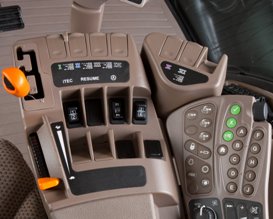 PST with Efficiency Manager on 9R Sraper Special Tractor
PST with Efficiency Manager on 9R Sraper Special Tractor

Exclusively designed for the 9R Series Tractors, the 18-speed full PowerShift Transmission with Efficiency Manager is standard on the 9460R - 9560R and 9RT Scraper Tractors. The 18-speed transmission features include:
- 18 forward speeds and six reverse speeds
- Able to shift from neutral up to 13th forward
- Speed matching from 18th forward to 13th forward
- Clutchless shuttle-shifting between 13th forward and sixth reverse
- Speeds are carefully spaced to take full advantage of engine power bulge and torque characteristics
- 10 speeds with a .5 mph speed change between gears in the 3-8 mph working range
- Allows selecting the right gear for the operation to ensure that best fuel economy and productivity are obtained
- Speeds carefully developed to match all of the tractor's needs
- Transmission-to-engine controller communication
The 9RT offers increased speed up to 40 K/h (25 mph). Gear ratios on the track tractors have increased approximately 16.5% across the board providing increased speed at respective levels on the 9030T.
Full powershifts for on-the-go shifting.
- No need to stop or clutch when changing speeds
- Forward-reverse shuttle shift with no clutching
- Transmission defaults to seventh gear whenever the tractor is started
9R Series Wheel Tractor - 18-speed PowerShift transmission (PST) with Efficiency Manager
|
Group 47 |
Group 48 |
||
|
(480R46, 20.8R42, 520R42, 620R42, |
(480R50, 520R46, 620R46, 710R42, |
||
Tire Size |
710R38) |
800R38) |
||
Engine (rpm) |
2100 |
2100 |
||
24-Speed Gear |
Mph |
Km/h |
Mph |
Km/h |
Range/Speed |
|
|
|
|
F1 |
2.54 |
4.08 |
2.69 |
4.33 |
F2 |
3.12 |
5.02 |
3.31 |
5.33 |
F3 |
3.45 |
5.55 |
3.66 |
5.89 |
F4 |
3.89 |
6.21 |
4.09 |
6.59 |
F5 |
4.25 |
6.84 |
4.50 |
7.25 |
F6 |
4.75 |
7.64 |
5.04 |
8.11 |
F7 |
5.25 |
8.45 |
5.57 |
8.97 |
F8 |
5.83 |
9.39 |
6.20 |
9.97 |
F9 |
6.46 |
10.40 |
6.86 |
11.04 |
F10 |
7.16 |
11.56 |
7.62 |
12.26 |
F11 |
7.93 |
12.77 |
8.42 |
13.55 |
F12 |
8.83 |
14.21 |
9.37 |
15.08 |
F13 |
9.77 |
15.72 |
10.36 |
16.68 |
F14 |
10.87 |
17.49 |
11.53 |
18.56 |
F15 |
13.43 |
21.62 |
14.25 |
22.94 |
F16 |
16.53 |
26.60 |
17.54 |
28.23 |
F17 |
20.29 |
32.66 |
21.53 |
34.65 |
F18 |
24.99 |
40.21 |
26.51 |
42.67 |
|
|
|
|
|
R1 |
2.54 |
4.08 |
2.69 |
4.33 |
R2 |
3.45 |
5.55 |
3.66 |
5.89 |
R3 |
3.89 |
6.21 |
4.09 |
6.59 |
R4 |
5.25 |
8.45 |
5.57 |
8.97 |
R5 |
5.83 |
9.39 |
6.20 |
9.97 |
R6 |
7.93 |
12.77 |
8.42 |
13.55 |
Group 47 Tire based on 710/70R38
Group 48 Tire based on 800/85R38
9R Series Track Tractor - 18-speed PowerShift transmission with Efficiency Manager
Engine (rpm) |
2100 |
|
Range/Speed |
Mph |
Km/h |
F1 |
2.53 |
4.07 |
F2 |
3.11 |
5.01 |
F3 |
3.44 |
5.54 |
F4 |
3.85 |
6.19 |
F5 |
4.23 |
6.81 |
F6 |
4.73 |
7.62 |
F7 |
5.23 |
8.42 |
F8 |
5.82 |
9.36 |
F9 |
6.44 |
10.37 |
F10 |
7.16 |
11.52 |
F11 |
7.91 |
12.73 |
F12 |
8.80 |
14.16 |
F13 |
9.74 |
15.67 |
F14 |
10.83 |
17.43 |
F15 |
13.39 |
21.55 |
F16 |
16.47 |
26.51 |
F17 |
20.23 |
32.55 |
F18 |
24.90 |
40.08 |
|
|
|
R1 |
2.53 |
4.07 |
R2 |
3.44 |
5.54 |
R3 |
3.85 |
6.19 |
R4 |
5.23 |
8.42 |
R5 |
5.82 |
9.36 |
R6 |
7.91 |
12.73 |
General maintenance
 9R, 9RT, and 9RX service access
9R, 9RT, and 9RX service access
Regular service and maintenance are essential to the performance, productivity, and longevity of all farm machinery.
Maximum uptime is an important element of productivity.
- 9 Family service points are quick and simple to check.
- Greater accessibility improves serviceability.
All items in the daily service schedule can be performed without the use of tools:
- Engine oil, hydraulic oil, coolant level, and water separator can be conveniently accessed from ground level without having to open the hood. Engine oil can be checked by simply removing one small engine side panel.
 Engine oil service point
Engine oil service point
- Engine can be easily accessed by simply raising the one-piece hood and removing two engine side panels for more periodic maintenance checks.
- Single-point latch mechanism ensures easy hood opening and closure.
NOTE: Always refer to the operator’s manual for complete maintenance and service recommendations.
Refueling
 Fuel tank on the 9R
Fuel tank on the 9R
 Refueling
Refueling
The 9R Series Tractors fuel tank is located over the rear axle. The fuel tank features a dual fill design. This design allows the machine to be filled from either side of the fuel tank. A fuel nozzle holder is located when the operator positions themselves on the gudgeon platform to fill the fuel tank.
The diesel exhaust fluid (DEF) tank is located on the left-hand side of the tractor indicated by a blue cap. It is fillable from ground level and has a protective shield to keep debris out of the fill neck.
Model |
Diesel |
DEF |
9370R |
1211 L (320 gal.) | 120 L (31.7 gal.) |
9420R |
1514 L (400 gal.)* | 120 L (31.7 gal.) |
9470R |
1514 L (400 gal.)* | 120 L (31.7 gal.) |
9520R |
1514 L (400 gal.) | 120 L (31.7 gal.) |
9570R |
1514 L (400 gal.) | 120 L (31.7 gal.) |
9620R |
1514 L (400 gal.) | 120 L (31.7 gal.) |
*When equipped with double-reduction axle. 1211-L (320-gal.) when equipped with single-reduction axle.
 Fuel tank on the left side of 9RT
Fuel tank on the left side of 9RT
The 9RT fuel tank is located behind the cab; the fuel fill is located conveniently on the left-hand main platform.
The 9RT Series Tractors all feature a DEF tank capacity of 93.9 L (24.8 gal.). The fill location is near the diesel fill location.
Model |
Diesel |
DEF |
9470RT |
1325 L (350 gal.) | 93.9 L (24.8 gal.) |
9520RT |
1325 L (350 gal.) | 93.9 L (24.8 gal.) |
9570RT |
1325 L (350 gal.) | 93.9 L (24.8 gal.) |
Model |
Diesel |
DEF |
9470RX |
1514 L (400 gal.) | 120 L (31.7 gal.) |
9520RX |
1514 L (400 gal.) | 120 L (31.7 gal.) |
9570RX |
1514 L (400 gal.) | 120 L (31.7 gal.) |
9620RX |
1514 L (400 gal.) | 120 L (31.7 gal.) |
NOTE:
- John Deere supports the usage of bio diesel. Bio diesel should meet ASTM D6751 (US) or EN 14214 (European) fuel quality standards.
- Tractors receive fuel containing a 2 percent bio-diesel blend at the factory.
- Acceptable blend levels may vary by geographic region.
- Diesel exhaust fluid will freeze when exposed for longer than three hours to conditions below -11°C (12.2° F).
For more information about the use of bio-diesel in John Deere engines, refer to www.JohnDeere.com/biodiesel.
DEF fill
9R, 9RT, and 9RX Series Tractors feature an easy-to-use DEF fill system. The 9R and 9RX feature a ground-level fill location, and DEF fill on 9RT is conveniently located on the step platform.
| Machine | DEF tank capacity |
| 9R | 120 L (31.7 gal.) |
| 9RT | 93.9 L (24.8 gal.) |
| 9RX | 120 L (31.7 gal.) |
 DEF tank on 9R/9RX
DEF tank on 9R/9RX
In-line DEF filter
9R, 9RT, and 9RX Series Tractors feature an in-line DEF filter to help protect the DEF pump from any contamination in the DEF tank. This in-line DEF filter is easily serviced with a drain plug to drain any remaining DEF from the filter housing and a replaceable cartridge-style filter.
 In-line DEF filter
In-line DEF filter
Severe-duty water separator, if equipped
The severe-duty water separator can extend service intervals and helps to protect the tractor’s fuel system from damage associated with lower-quality fuel.
Simply open the drain valve on the bottom of the separator and drain accumulated water.
NOTE: Cummins® QSX 15 L (915.4-cu in.) engines cannot be equipped with a severe-duty water separator; however, the fuel filter has separating capabilities like the primary filter on John Deere Power System engines.
Engine access
 Engine access on 9RX
Engine access on 9RX
The tilt hood and side panel design provides additional engine compartment protection. The 9R, 9RT, and 9RX hoods feature the same design for access to engine components.
Pull out the hood release (located on the front, left side) and tilt hood back to open. Engine side panels are quickly and easily removed for access to periodic maintenance items.
 Removing side engine panel
Removing side engine panel
Transmission, hydraulic, and axle oil level
 Sight gauge on 9R and 9RX
Sight gauge on 9R and 9RX
 Sight gauge on 9RT
Sight gauge on 9RT
A sight glass for the transmission, hydraulic, and axle oil level is located at the back right side of the gudgeon, indicating proper oil levels, and an oil fill neck is located on the back right side of the gudgeon for the 9R and 9RX Series Tractor. The oil fill is located on the top of the common reservoir on the left side of the 9RT Series Tractor and a fill tube is located between the steps and engine of the tractor.
- Provides increased filter capacity compared to previous 9R and 9RT Series Tractors
- Transmission, hydraulic, and axle oil should be changed every 1500 hours
- Filter should be changed every 1500 hours unless filter restriction code occurs
- Daily and 10-hour inspections of the transmission hydraulic oil level are recommended
NOTE: The tractor should be off and parked on level ground with the hitch in the lowered position when checking the oil level.
- Sight glass observations will be significantly higher with hot oil temperatures and lower with cold oil or if engine has not run long enough.
NOTE: Oil level above the top mark on the sight glass can result in power loss and heat generation during transport applications.
Primary air filter access
 Primary engine air filter inspection
Primary engine air filter inspection
On the 9R and 9RX, the primary engine air filter is accessible from the left-hand platform for replacement annually or as operating conditions require. The filter is aspirated and extends filter life in dusty conditions by aspirating more than 95 percent of incoming dust. Aspirator suction is created by utilizing the air flow from the cooling fan.
On the 9RT, the primary engine air filter is located at ground level on right side of tractor.
Oil change intervals
 Engine oil check/fill location
Engine oil check/fill location
Tractors with the 9.0L (549.2-cu in.) and 13.5L (823.2-cu in.) John Deere Power Systems engines feature a 500-hour change interval when using approved John Deere Plus-50™ II oil and a John Deere oil filter.
Tractors equipped with the Cummins QSX 15-L (915.4-cu in.) engine have a 400-hour engine oil and oil filter change interval.
- Previous initial oil and filter change at 100 hours is no longer required due to the factory fill of Break-In™ Plus oil.
- If using anything other than John Deere Plus-50 II oil, a 250-hour change interval is required. CJ-4 must still be used.
- Only use ultra-low sulfur diesel fuel and CJ-4, ACEA E9, or ACEA E6 oil.
- An oil change of 500 hours is possible when using fuel with less than 15 parts per million (ppm) of sulfur, along with John Deere Plus-50 II oil.
See the tractor's operator's manual for oil change intervals and further details.
Battery access
 Battery location on 9R and 9RX
Battery location on 9R and 9RX
 Battery location on 9RT
Battery location on 9RT
The 9R and 9RX battery location is behind the left-hand step assembly. There are three bolts that secure the swinging step assembly that need to be removed to completely access the batteries. The 9RT top step of the platform conceals the tractor’s three 12-V batteries with 2775 CCA (925-CCA each). Tractors with the Cummins X15 engine will have four 12-V batteries in the same location as tractors equipped with John Deere Power System engines.
Although the batteries are maintenance free, conditions such as long periods of operation at high ambient temperatures and excessive engine cranking may require adding water.
Battery boost terminal
 Battery boost terminal
Battery boost terminal
On the 9R and 9RX, a battery boost terminal is located on the left-hand side of the engine for convenient and proper boost assisted starting.
Fuse and relay panel
 Fuse and relay panel
Fuse and relay panel
The electrical fuse and relay panel is located behind the operator’s seat and just below the cab's rear window. Simply lift up on the operator manual cover for access.
- Contains easy-to-replace automotive blade-type fuses and relays for quick servicing.
- Spare fuses are provided for each amperage size used.
The diode module contains many of the diodes contained in the system:
- If a diode problem occurs, simply replace the diode module for easy service and increased uptime.
- Relays are also fully interchangeable for quick service.
Electrical system (smart load center)
The electrical system provides a full controller area network (CAN) bus based system on the tractor for improved tractor implement integration and flexibility. Incorporated with the system is a smart load center, which provides fewer fuses, fewer connectors, and simplified wiring for increased reliability.
The solid-state load center’s primary function is to control the majority of high-current loads, such as fender floodlights and the horn. This electronic circuitry will monitor loads and voltages to provide fast reaction time and the ability to alert the operator if a circuit overloads or if voltage is out of specification – for example, open circuit (undercurrent) or short circuit (overcurrent).
Cab air filters
 Cab fresh air filter inspection
Cab fresh air filter inspection
 Cab recirculation filter
Cab recirculation filter
The cab fresh air filter is conveniently located beneath the left side of the cab for all 9 Family products:
- External service means no mess in the cab from dusty filters
- Filter housing acts as a dust accumulator compartment
- Hand screw eliminates need for tools
- Replace cab fresh air filter every 1000 hours or sooner if plugged or damaged
Cab air recirculation filter
Cab air recirculation filter is located in the roof liner above the operator. 70 percent of the total air volume is recirculated with a blanket effect for enhanced operator comfort.
- Replace cab air recirculation filter every 1000 hours or sooner if plugged or damaged.
Cab air filters are not designed to filter out harmful chemicals. Follow the instructions in the implement operator’s manual and those given by the chemical manufacturer when using agricultural chemicals.
Windshield washer
 Windshield washer bottle on 9R and 9RX
Windshield washer bottle on 9R and 9RX
The windshield washer bottle is optional on 9R and 9RX Tractors and is located on the left side of the tractor near the DEF fill point. On 9RT Tractors, it is located on the right-side frame.
Maintenance-free U-joint
Maintenance-free U-joint bearings require no servicing to reduce maintenance time.
Toolbox
 Toolbox for 9R, 9RT and 9RX
Toolbox for 9R, 9RT and 9RX
A convenient toolbox is located on the left-hand side of the front frame for tool storage and comes standard on all 9R, 9RT, and 9RX Series Tractors.
9R and 9RX Series Tractors have an additional storage box conveniently located on top the left-hand platform.
The 9RT has an additional toolbox conveniently located next to the left side of the batteries for additional storage.
Cummins is a trademark of Cummins, Inc.
Tow cable attachment
 Tow cable front hook
Tow cable front hook
 Rear tow cable connection point
Rear tow cable connection point
The front tow cable is recommended for pulling all 9 Family Tractors in time of needed assistance. Tow cables are available as a factory-installed option on all ag tractors and are base equipment on all Scraper Special Tractors. The tow cable attaches to the area in front of the drawbar and is also available as a field-installed option.
Features
Cummins® X15 (15-L [912 cu in] displacement) engine
 9RT engine
9RT engine
 9RT with Cummins X15 15.0L engine
9RT with Cummins X15 15.0L engine
John Deere and Cummins have partnered to provide customers with a reliable, productive and efficient engine solution in the X15. Extensive work has been done between John Deere and Cummins on software development and other engine/tractor application interface points to provide producers with the performance and efficiency they have come to expect from John Deere.
The X15 has followed the same building block approach to meet emissions requirements as similar John Deere engines. This allows John Deere to provide common technologies to producers throughout different horsepower and engine displacement offerings ensuring a consistent experience for producers. Just like the other two engine offerings in the 9 Family of tractors, the X15 features exhaust gas recirculation (EGR) and an exhaust aftertreatment combination of a diesel particulate filter (DPF) and selective catalytic reduction (SCR) to meet the near-zero NOx and particulate matter (PM) emissions standards.
X15 technology
XPI fuel system – the XPI common-rail fuel system delivers a precise quantity of fuel at ultra-high pressures. This, together with electronic engine controls, enables multiple injection events per cycle. Flexibility in injection timing increases fuel economy and performance while decreasing exhaust emissions.
VGT turbocharger – the X15 utilizes a single Cummins VGT™ turbocharger which features electric actuation for infinite adjustment.
Cooled EGR –system has been rebalanced for use with SCR, reducing flow volume and minimizing diesel exhaust fluid (DEF) consumption levels.
Fully integrated electronic controls – a single electronic control module (ECM) controls everything from air intake to exhaust aftertreatment.
Cummins particulate filter and SCR – Cummins particulate filter operates as a nearly passive device, with minimal regeneration required.
Cummins and VGT are a trademarks of Cummins Inc.
Standard CommandView™ III cab offers unsurpassed amenities
 CommandView III cab
CommandView III cab
The standard CommandView III cab offers unsurpassed visibility, operator comfort, control placement, and ride and sound quality.
Features:
- ComfortCommand™ seat with air suspension, lumbar support, swivel, fore-aft and lateral attenuation, backrest angle adjustment, adjustable left-hand armrest, and 40-degree right-hand seat swivel
- Operator presence system that warns if the operator is out of the seat while operating key functions
- Folding instructional seat
- CommandARM™ control center with integrated controls
- 4100 or 4600 Generation 4 CommandCenter™ processor
- Behind-the-seat storage
- Left-hand storage compartment
- Passive noise reduction system
- Service ADVISOR™ diagnostic system data port
- Tilt/telescoping steering wheel with position memory
- Swing-out rear window, opens 30 degrees
- Right- and left-outside mirrors (manually adjustable mirror head)
- Monitor mounts on right-hand front post and rear cab post
- Standard radio package, including AM/FM stereo and weatherband with remote controls, auxiliary input jack, four speakers, and an external antenna
- Laminated glass
- Air conditioner and heater with automatic temperature controls (ATC)
- Two 12-V convenience outlet (cigarette lighter style)
- One 12-V 3-pin outlet with adapter (provides switched and unswitched power)
- One International Organization for Standardization (ISO) nine-pin connector
- Power strip with convenience plug adapter
- Hitch control lever lock and selective control lever lock
- Two-speed and intermittent front and rear wiper with washer
- Front pull-down sunshade
- Digital cornerpost display with:
- Fuel level gauge, including low fuel warning
- Temperature gauge
- Diesel exhaust fluid (DEF) gauge, including low DEF warning
- Engine rpm
- Transmission commanded gear or speed
- Vehicle system functions, such as iTEC™ end-row guidance, that are operating
- Inside-mounted rearview mirror
- Beverage holders sized to accommodate various containers
- Interior left-hand dome light
ComfortCommand seat
 ComfortCommand seat
ComfortCommand seat
ComfortCommand seat improves ride quality and helps to reduce operator fatigue
Features include:
- Armrests, lumbar support, and backrest angle are easily adjusted to match operator preference.
- Shock absorbers dampen the motion effect of the tractor for an improved ride.
- Seat height adjustments are conveniently located on the left armrest.
- Fore-aft adjustment is easy to reach located on the left front of the seat.
- Swivel adjustment, located on the front of the seat, allows the seat to be swiveled 40 degrees to the right or eight degrees to the left of the center position.
- Operator presence switch warns if the operator is out of the seat while operating key functions.
- Seat belt retractor.
- Centered cab seat, providing excellent over-shoulder visibility.
- Adjustable shock absorber permitting ride adjustment from soft to firm to match the operator's desired comfort level.
- Removable cushions for easy cleaning.
CommandARM
 CommandARM controls
CommandARM controls
John Deere 9 Family Tractors feature the CommandARM with integrated Generation 4 CommandCenter display. The control layout of the CommandARM utilizes a clean and efficient design which groups controls by function and builds upon John Deere’s history of intuitive and ergonomic control placement and operation. The design of the CommandARM allows for a 40-degree right seat swivel and adjustable positioning matching the operator’s preference.
Controls located on the CommandARM include:
- Engine throttle
- Transmission control for e18™ transmission speed PowerShift™ transmission
- Eco mode (minimum engine speed) for e18 speed PowerShift transmission
- FieldCruise™ engine controls
- Selective control valve (SCV) controls
- AutoLoad™ controls (if equipped)
- Differential lock on/off and automatic
- iTEC™ sequence switches
- AutoTrac™ assisted steering system resume switch (if equipped)
- Radio
- Beacon light on/off
- Hazard lights on/off
- Field lights 1/2
- Heating, ventilation, air-conditioning (HVAC) system
Hydraulic controls
Hydraulic controls utilize fingertip paddle pots for raise/lower and extend/retract functions.
 Fingertip paddle pots
Fingertip paddle pots
Throttle
The throttle design incorporates buttons which control FieldCruise speed, and transmission eco settings.
 Throttle
Throttle
Tractor function controls
Located just to the right of the throttle is the Auto-Trac activation button and four sequence controls for iTEC functions. Behind the iTEC sequence controls there are buttons which control the activation and deactivation of differential lock. Differential lock can also be activated by the foot switch on the cab floor.
 AutoTrac resume and iTEC strip
AutoTrac resume and iTEC strip
Controls for radio, lights, rotary beacon (if equipped), hazard flashers, and HVAC system are located to the center-right on the CommandARM, along with power take-off (PTO) for rear PTO.
 Radio, HVAC, hazard flashers, and PTO controls
Radio, HVAC, hazard flashers, and PTO controls
Seat swivel
The design of the CommandARM allows for up to 40 degrees of right-hand seat swivel.
 Seat swivel
Seat swivel
 40-degree seat swivel shown
40-degree seat swivel shown
CommandCenter
 Generation 4 CommandCenter
Generation 4 CommandCenter
The Generation 4 CommandCenters features fast adjustment of tractor functions and controls and are integrated into the CommandARM to create a seamless control center.
The following functions can be adjusted and accessed using the CommandCenter display:
- Hydraulic settings
- Hitch settings
- Transmission settings
- FieldCruise
- iTEC programming functions
- Radio
- Lights
- Add all functionality – diagnostics, display settings, etc.
The Generation 4 CommandCenter systems have the capability of Remote Display Access (RDA). RDA allows improved communication between an offsite farm manager or dealer and the equipment operator. The user can view exactly what the operator sees on the GreenStar™ 3 2630 Display and Generation 4 CommandCenter from almost any internet-connected device. RDA is available on the 4600 and 4100 CommandCenter and allows for an increase in productivity with quicker problem resolution. By using RDA, the cost of operation will decrease due to reduced labor and travel costs, and maximum efficiency will increase profit.
e18™ PowerShift™ transmission with Efficiency Manager™ feature
The e18 transmission delivers smooth shifting and intuitive controls in a reliable 18-speed PowerShift transmission. The e18 transmission with enhanced Efficiency Manager is standard equipment on all 9 Family Tractors.
The e18 has evolved from more than 50 years of John Deere PowerShift technology. With more automatic features, the e18 is easy to operate for all levels of operators and operations. It features three modes of operation, full AUTO, custom, and manual modes. Full AUTO and custom modes manage the engine and transmission to match the desired ground speed to the field conditions. These two modes are ideal for most conditions and take the guess work out of operation. Manual mode is perfect for operators looking to operate the e18 like a traditional PowerShift by bump shifting and managing the engine throttle to their liking.
As the next generation of PowerShift technology, the e18 delivers the strength to handle sudden, high-torque power loads while maintaining responsive, quick, and smooth shifts.
e18 controls
 Shift lever and hand throttle
Shift lever and hand throttle
CommandCenter™ controls
 254-mm (10-in.) Generation 4 CommandCenter
254-mm (10-in.) Generation 4 CommandCenter
The CommandCenter is the central information system for tractors and allows the operator to program various settings tailored to a specific operation.
To access the tractor’s transmission settings, press the transmission shortcut button on the CommandCenter shortcut bar.
 CommandCenter transmission shortcut button
CommandCenter transmission shortcut button
Operating modes
The e18 application settings employ three modes to take full advantage of the engine-transmission communication: Full AUTO mode, custom mode, and manual mode.
Full AUTO mode
 Full AUTO main page
Full AUTO main page
Full AUTO mode manages the tractor’s engine and transmission inputs to reach and maintain the desired ground speed set by the operator. This means the tractor will manage shifts and engine rpm to operate at the most efficient level possible. Operators have the ability to set the maximum forward and reverse speeds for their particular applications. In full AUTO mode the operator can adjust the desired ground speed in two ways, by conducting a traditional bump shift or by rotating the dial on the thumb wheel.
When shifting in full AUTO mode, the transmission shifts set speeds and does not always shift gears, meaning the transmission may not necessarily shift gears if it can reach the desired ground speed with a slightly higher or lower engine rpm. Efficiency Manager is automatically engaged while operating in full AUTO mode. As a result, shifting will not take the tractor out of Efficiency Manager in full AUTO mode.
Custom mode
 e18 custom transmission page
e18 custom transmission page
Custom mode operates similar to full AUTO mode but allows operators to adjust operating parameters to meet a specific operation. It also has the ability to activate eco mode for a higher level of operation.
 Eco button
Eco button
 Display screen
Display screen
Eco allows two minimum engine speeds to be set. Operators can turn eco on and off by either pushing the eco button on the side of the throttle or by selecting eco in the transmission settings page of the CommandCenter controls. For example, operators may choose to turn eco on during transport to utilize a lower minimum engine speed and then turn eco off while operating in the field where a higher minimum engine speed is desired.
 Custom settings page
Custom settings page
In the advanced settings page, operators can customize the auto shift engine speed droop as a percentage of the full engine speed. In addition, the load anticipation feature can be enabled for the hitch engagement, hydraulic engagement, or both.
Manual mode
Manual mode operates very similarly to a traditional PowerShift transmission with Efficiency Manager.
In manual mode the operator manages the engine and transmission inputs by controlling the shift lever and hand throttle.
 Manual mode page
Manual mode page
Efficiency Manager
 Set speed buttons and set speed adjuster
Set speed buttons and set speed adjuster
Efficiency Manager is automatically enabled in auto and custom modes. Efficiency Manager can be turned on in manual mode by selecting the set speed one or set speed two button on the CommandARM™ console. The set speed adjuster on the top of the single-lever gear selector allows the operator to dial in the desired ground speed to establish set speed one or two. Once engaged, Efficiency Manager will manage the engine rpm and gear selection to maintain the desired working speed. To reach the desired set speed, the throttle must be set to full engine rpm.
e18 operation
 e18 operation
e18 operation
Setting start-up gears
The 9 Family Tractors default to 7F and 2R at start up. However, these default start-up gears can be adjusted from 1-13F and 1-3R through the CommandCenter. Refer to the operator’s manual for additional information.
 Start-up gears in advanced settings
Start-up gears in advanced settings
9R Series Tractor - e18-speed chart for PowerShift transmission with Efficiency Manager
9R table
Group 47 tires |
Group 48 tires |
|||
Tire size |
(480R46, 20.8R42, 520R42, 620R42, 710R38) |
(480R50, 520R46, 620R46, 710R42, 800R38) |
||
Engine (rpm) |
2100 |
2100 |
||
18-speed gear |
km/h |
mph |
km/h |
mph |
Forward gears |
||||
F1 |
4.0 |
2.5 |
4.2 |
2.6 |
F2 |
4.8 |
3.0 |
5.0 |
3.1 |
F3 |
5.3 |
3.3 |
5.6 |
3.5 |
F4 |
5.9 |
3.7 |
6.2 |
3.9 |
F5 |
6.5 |
4.0 |
6.8 |
4.3 |
F6 |
7.3 |
4.5 |
7.6 |
4.8 |
F7 |
8.0 |
5.0 |
8.5 |
5.3 |
F8 |
9.0 |
5.6 |
9.5 |
5.9 |
F9 |
9.9 |
6.1 |
10.4 |
6.5 |
F10 |
11.0 |
6.9 |
11.6 |
7.2 |
F11 |
12.2 |
7.6 |
12.9 |
8.0 |
F12 |
13.5 |
8.4 |
14.2 |
8.8 |
F13 |
15.0 |
9.3 |
15.8 |
9.8 |
F14 |
16.6 |
10.3 |
17.5 |
10.9 |
F15 |
20.5 |
12.8 |
21.6 |
13.4 |
F16 |
25.3 |
15.7 |
26.6 |
16.5 |
F17 |
31.2 |
19.4 |
32.9 |
20.4 |
F18 |
38.5 |
23.9 |
40.5 |
25.2 |
Reverse gears |
||||
R1 |
3.9 |
2.4 |
4.1 |
2.5 |
R2 |
5.3 |
3.3 |
5.6 |
3.5 |
R3 |
5.9 |
3.7 |
6.2 |
3.9 |
R4 |
8.0 |
5.0 |
8.5 |
5.3 |
R5 |
9.0 |
5.6 |
9.5 |
5.9 |
R6 |
12.2 |
7.6 |
12.9 |
8.0 |
Group 47 tire based on 710/70R38
Group 48 tire based on 800/80R38
9RT and 9RX Series Tractor - e18-speed chart for PowerShift transmission with Efficiency Manager
9RT and 9RX table
|
9RT |
9RX |
||
Engine (rpm) |
2100 |
2100 |
||
18-speed gear |
km/h |
mph |
km/h |
mph |
Forward gears |
|
|
|
|
F1 |
4.0 |
2.5 |
4.0 |
2.5 |
F2 |
5.0 |
3.1 |
4.9 |
3.0 |
F3 |
5.5 |
3.4 |
5.5 |
3.4 |
F4 |
6.1 |
3.8 |
6.1 |
3.8 |
F5 |
6.8 |
4.2 |
6.7 |
4.2 |
F6 |
7.6 |
4.7 |
7.5 |
4.7 |
F7 |
8.4 |
5.2 |
8.3 |
5.2 |
F8 |
9.3 |
5.8 |
9.2 |
5.7 |
F9 |
10.3 |
6.4 |
10.2 |
6.3 |
F10 |
11.4 |
7.1 |
11.4 |
7.1 |
F11 |
12.6 |
7.8 |
12.6 |
7.8 |
F12 |
14.1 |
8.7 |
14.0 |
8.7 |
F13 |
15.6 |
9.7 |
15.5 |
9.6 |
F14 |
17.3 |
10.7 |
17.2 |
10.3 |
F15 |
21.4 |
13.3 |
21.3 |
13.2 |
F16 |
26.3 |
16.3 |
26.2 |
16.3 |
F17 |
32.3 |
20.1 |
32.2 |
20.0 |
F18 |
39.8 |
24.7 |
39.6 |
24.6 |
Reverse gears |
|
|
|
|
R1 |
4.0 |
2.5 |
4.0 |
2.5 |
R2 |
5.5 |
3.4 |
5.5 |
3.4 |
R3 |
6.1 |
3.3 |
6.1 |
3.8 |
R4 |
7.3 |
3.8 |
8.3 |
5.2 |
R5 |
9.3 |
5.8 |
9.2 |
5.7 |
R6 |
12.6 |
7.8 |
12.6 |
10.3 |
JDLink™ services and Service ADVISOR™ diagnostic systems
JDLink
 JDLink Dashboard
JDLink Dashboard
JDLink is the John Deere telematics system designed for operators and managers who desire to take their operations to the next level of productivity and efficiency without leaving the office. Whether it is receiving an e-mail or text message, users can manage the operation in real-time without being in the cab. Using the power of JDLink can optimize productivity, increase uptime, and boost profits with JDLink information all accessible from a laptop, desktop, or mobile device.
JDLink Ultimate provides enhanced machine performance and utilization information that can only be achieved through direct communication with on-board machine controllers. Utilizing John Deere-exclusive telematics technology, users can remotely link to Ultimate-compatible machines to achieve a new level of optimization.
NOTE: Mobile device compatibility and functionality varies.
Monitor assets, performance, and more with JDLink:
- Increase uptime and reduce time spent managing equipment with JDLink Ultimate
- Coordinate machine and labor logistics
- Unleash new possibilities with wireless machine connectivity
- Locate machines on-the-go with the JDLink app for iPhone®, iPad® or Android™ devices
- Leverage common components from the JDLink system to enable remote support and machine monitoring
- Industry-exclusive Service ADVISOR Remote with JDLink (Canada link)
For more information on JDLink activations and subscriptions, visit www.StellarSupport.com.
NOTE: JDLink is not available in all geographic regions.
Service ADVISOR
 Service ADVISOR
Service ADVISOR
Service ADVISOR diagnostics greatly assist in reducing service costs and downtime. It allows the John Deere service technician to readily extract vital information about tractor malfunctions through the Service ADVISOR data port. Diagnostic codes and controller area network (CAN) bus statistics stored by the tractor and visible in the CommandCenter™ display are used by service technicians to isolate, identify, and resolve problems.
Diagnostics and CAN bus statistics are not normally used by the operator. Access and use of trouble codes should only be done by a qualified, factory-trained John Deere service technician.
Service ADVISOR Remote
Service ADVISOR Remote takes the machine connectivity of JDLink and takes it one step further. With Service ADVISOR Remote, machines can be diagnosed remotely, saving the cost of a field service call. For example, diagnostic trouble codes can be reset and software updates can be uploaded remotely.
Apple, iPhone, and iPad are trademarks of Apple Inc. Android is a trademark of Google LLC.
High flow hydraulics, 115 gpm (435-L/min) system
 High flow hydraulics
High flow hydraulics

The 115-gpm (435 L/min) hydraulic system (order code 2813) is designed to reduce scraper hydraulic cycle times, thus increasing the efficiency of the tractor/scraper combination.
Two hydraulic pumps are combined for a total of 115-gpm (435 L/min). Flow through one 19.1-mm (3/4-in.) SCV is 45 gpm (140 L/min). The selective control valves (SCVs) are designed for commercial applications. This system is not recommended for agricultural implements with continuous flow requirements. When maximum hydraulic pump capacity is reached, multiple functions will continue to operate at the same proportional flow rate. This will prevent the rear scraper from slowing down, in relation to the front scraper, when operating the front and rear scrapers at the same time.
When ordering this scraper high-flow option, the tractor will come standard with four SCVs. The two system pumps provide their combined oil flow of 115 gpm (435 L/min) to all four SCVs through a common valve manifold. All of the SCV oil returns to one common reservoir.
19.1-mm (3/4-in.) couplers reduce restriction for increased flow to the scraper. A secondary lowering function accumulator is included with the hydraulic valves so the scraper can be lowered if hydraulic power is lost.
NOTE: This system is not recommended with agricultural implements with continuous flow demand (scraper applications only).
IMPORTANT: Do not use this system with scrapers/implements with 12.7-mm (1/2-in.) couplers/hoses/hydraulic systems. Damage could occur to implement hoses/couplers/components due to high-flow capability of the tractor system.
NOTE: Power Beyond connections are not recommended for use with scraper systems or high hydraulic oil take out demand (example: large or multiple single acting cylinders, raising multiple scraper pans). Power Beyond connections are recommended for agricultural equipment with continuous flow demands (example: variable rate drives, CCS fans).
General maintenance
 9R, 9RT, and 9RX service access
9R, 9RT, and 9RX service access
Regular service and maintenance are essential to the performance, productivity, and longevity of all farm machinery.
Maximum uptime is an important element of productivity.
- 9 Family service points are quick and simple to check.
- Greater accessibility improves serviceability.
All items in the daily service schedule can be performed without the use of tools:
- Engine oil, hydraulic oil, coolant level, and water separator can be conveniently accessed from ground level without having to open the hood. Engine oil can be checked by simply removing one small engine side panel.
 Engine oil service point
Engine oil service point
- Engine can be easily accessed by simply raising the one-piece hood and removing two engine side panels for more periodic maintenance checks.
- Single-point latch mechanism ensures easy hood opening and closure.
NOTE: Always refer to the operator’s manual for complete maintenance and service recommendations.
Refueling
 Fuel tank on the 9R
Fuel tank on the 9R
 Refueling
Refueling
The 9R Series Tractors fuel tank is located over the rear axle. The fuel tank features a dual fill design. This design allows the machine to be filled from either side of the fuel tank. A fuel nozzle holder is located when the operator positions themselves on the gudgeon platform to fill the fuel tank.
The diesel exhaust fluid (DEF) tank is located on the left-hand side of the tractor indicated by a blue cap. It is fillable from ground level and has a protective shield to keep debris out of the fill neck.
Model |
Diesel |
DEF |
9370R |
1211 L (320 gal.) | 120 L (31.7 gal.) |
9420R |
1514 L (400 gal.)* | 120 L (31.7 gal.) |
9470R |
1514 L (400 gal.)* | 120 L (31.7 gal.) |
9520R |
1514 L (400 gal.) | 120 L (31.7 gal.) |
9570R |
1514 L (400 gal.) | 120 L (31.7 gal.) |
9620R |
1514 L (400 gal.) | 120 L (31.7 gal.) |
*When equipped with double-reduction axle. 1211-L (320-gal.) when equipped with single-reduction axle.
 Fuel tank on the left side of 9RT
Fuel tank on the left side of 9RT
The 9RT fuel tank is located behind the cab; the fuel fill is located conveniently on the left-hand main platform.
The 9RT Series Tractors all feature a DEF tank capacity of 93.9 L (24.8 gal.). The fill location is near the diesel fill location.
Model |
Diesel |
DEF |
9470RT |
1325 L (350 gal.) | 93.9 L (24.8 gal.) |
9520RT |
1325 L (350 gal.) | 93.9 L (24.8 gal.) |
9570RT |
1325 L (350 gal.) | 93.9 L (24.8 gal.) |
Model |
Diesel |
DEF |
9470RX |
1514 L (400 gal.) | 120 L (31.7 gal.) |
9520RX |
1514 L (400 gal.) | 120 L (31.7 gal.) |
9570RX |
1514 L (400 gal.) | 120 L (31.7 gal.) |
9620RX |
1514 L (400 gal.) | 120 L (31.7 gal.) |
NOTE:
- John Deere supports the usage of bio diesel. Bio diesel should meet ASTM D6751 (US) or EN 14214 (European) fuel quality standards.
- Tractors receive fuel containing a 2 percent bio-diesel blend at the factory.
- Acceptable blend levels may vary by geographic region.
- Diesel exhaust fluid will freeze when exposed for longer than three hours to conditions below -11°C (12.2° F).
For more information about the use of bio-diesel in John Deere engines, refer to www.JohnDeere.com/biodiesel.
DEF fill
9R, 9RT, and 9RX Series Tractors feature an easy-to-use DEF fill system. The 9R and 9RX feature a ground-level fill location, and DEF fill on 9RT is conveniently located on the step platform.
| Machine | DEF tank capacity |
| 9R | 120 L (31.7 gal.) |
| 9RT | 93.9 L (24.8 gal.) |
| 9RX | 120 L (31.7 gal.) |
 DEF tank on 9R/9RX
DEF tank on 9R/9RX
In-line DEF filter
9R, 9RT, and 9RX Series Tractors feature an in-line DEF filter to help protect the DEF pump from any contamination in the DEF tank. This in-line DEF filter is easily serviced with a drain plug to drain any remaining DEF from the filter housing and a replaceable cartridge-style filter.
 In-line DEF filter
In-line DEF filter
Severe-duty water separator, if equipped
The severe-duty water separator can extend service intervals and helps to protect the tractor’s fuel system from damage associated with lower-quality fuel.
Simply open the drain valve on the bottom of the separator and drain accumulated water.
NOTE: Cummins® QSX 15 L (915.4-cu in.) engines cannot be equipped with a severe-duty water separator; however, the fuel filter has separating capabilities like the primary filter on John Deere Power System engines.
Engine access
 Engine access on 9RX
Engine access on 9RX
The tilt hood and side panel design provides additional engine compartment protection. The 9R, 9RT, and 9RX hoods feature the same design for access to engine components.
Pull out the hood release (located on the front, left side) and tilt hood back to open. Engine side panels are quickly and easily removed for access to periodic maintenance items.
 Removing side engine panel
Removing side engine panel
Transmission, hydraulic, and axle oil level
 Sight gauge on 9R and 9RX
Sight gauge on 9R and 9RX
 Sight gauge on 9RT
Sight gauge on 9RT
A sight glass for the transmission, hydraulic, and axle oil level is located at the back right side of the gudgeon, indicating proper oil levels, and an oil fill neck is located on the back right side of the gudgeon for the 9R and 9RX Series Tractor. The oil fill is located on the top of the common reservoir on the left side of the 9RT Series Tractor and a fill tube is located between the steps and engine of the tractor.
- Provides increased filter capacity compared to previous 9R and 9RT Series Tractors
- Transmission, hydraulic, and axle oil should be changed every 1500 hours
- Filter should be changed every 1500 hours unless filter restriction code occurs
- Daily and 10-hour inspections of the transmission hydraulic oil level are recommended
NOTE: The tractor should be off and parked on level ground with the hitch in the lowered position when checking the oil level.
- Sight glass observations will be significantly higher with hot oil temperatures and lower with cold oil or if engine has not run long enough.
NOTE: Oil level above the top mark on the sight glass can result in power loss and heat generation during transport applications.
Primary air filter access
 Primary engine air filter inspection
Primary engine air filter inspection
On the 9R and 9RX, the primary engine air filter is accessible from the left-hand platform for replacement annually or as operating conditions require. The filter is aspirated and extends filter life in dusty conditions by aspirating more than 95 percent of incoming dust. Aspirator suction is created by utilizing the air flow from the cooling fan.
On the 9RT, the primary engine air filter is located at ground level on right side of tractor.
Oil change intervals
 Engine oil check/fill location
Engine oil check/fill location
Tractors with the 9.0L (549.2-cu in.) and 13.5L (823.2-cu in.) John Deere Power Systems engines feature a 500-hour change interval when using approved John Deere Plus-50™ II oil and a John Deere oil filter.
Tractors equipped with the Cummins QSX 15-L (915.4-cu in.) engine have a 400-hour engine oil and oil filter change interval.
- Previous initial oil and filter change at 100 hours is no longer required due to the factory fill of Break-In™ Plus oil.
- If using anything other than John Deere Plus-50 II oil, a 250-hour change interval is required. CJ-4 must still be used.
- Only use ultra-low sulfur diesel fuel and CJ-4, ACEA E9, or ACEA E6 oil.
- An oil change of 500 hours is possible when using fuel with less than 15 parts per million (ppm) of sulfur, along with John Deere Plus-50 II oil.
See the tractor's operator's manual for oil change intervals and further details.
Battery access
 Battery location on 9R and 9RX
Battery location on 9R and 9RX
 Battery location on 9RT
Battery location on 9RT
The 9R and 9RX battery location is behind the left-hand step assembly. There are three bolts that secure the swinging step assembly that need to be removed to completely access the batteries. The 9RT top step of the platform conceals the tractor’s three 12-V batteries with 2775 CCA (925-CCA each). Tractors with the Cummins X15 engine will have four 12-V batteries in the same location as tractors equipped with John Deere Power System engines.
Although the batteries are maintenance free, conditions such as long periods of operation at high ambient temperatures and excessive engine cranking may require adding water.
Battery boost terminal
 Battery boost terminal
Battery boost terminal
On the 9R and 9RX, a battery boost terminal is located on the left-hand side of the engine for convenient and proper boost assisted starting.
Fuse and relay panel
 Fuse and relay panel
Fuse and relay panel
The electrical fuse and relay panel is located behind the operator’s seat and just below the cab's rear window. Simply lift up on the operator manual cover for access.
- Contains easy-to-replace automotive blade-type fuses and relays for quick servicing.
- Spare fuses are provided for each amperage size used.
The diode module contains many of the diodes contained in the system:
- If a diode problem occurs, simply replace the diode module for easy service and increased uptime.
- Relays are also fully interchangeable for quick service.
Electrical system (smart load center)
The electrical system provides a full controller area network (CAN) bus based system on the tractor for improved tractor implement integration and flexibility. Incorporated with the system is a smart load center, which provides fewer fuses, fewer connectors, and simplified wiring for increased reliability.
The solid-state load center’s primary function is to control the majority of high-current loads, such as fender floodlights and the horn. This electronic circuitry will monitor loads and voltages to provide fast reaction time and the ability to alert the operator if a circuit overloads or if voltage is out of specification – for example, open circuit (undercurrent) or short circuit (overcurrent).
Cab air filters
 Cab fresh air filter inspection
Cab fresh air filter inspection
 Cab recirculation filter
Cab recirculation filter
The cab fresh air filter is conveniently located beneath the left side of the cab for all 9 Family products:
- External service means no mess in the cab from dusty filters
- Filter housing acts as a dust accumulator compartment
- Hand screw eliminates need for tools
- Replace cab fresh air filter every 1000 hours or sooner if plugged or damaged
Cab air recirculation filter
Cab air recirculation filter is located in the roof liner above the operator. 70 percent of the total air volume is recirculated with a blanket effect for enhanced operator comfort.
- Replace cab air recirculation filter every 1000 hours or sooner if plugged or damaged.
Cab air filters are not designed to filter out harmful chemicals. Follow the instructions in the implement operator’s manual and those given by the chemical manufacturer when using agricultural chemicals.
Windshield washer
 Windshield washer bottle on 9R and 9RX
Windshield washer bottle on 9R and 9RX
The windshield washer bottle is optional on 9R and 9RX Tractors and is located on the left side of the tractor near the DEF fill point. On 9RT Tractors, it is located on the right-side frame.
Maintenance-free U-joint
Maintenance-free U-joint bearings require no servicing to reduce maintenance time.
Toolbox
 Toolbox for 9R, 9RT and 9RX
Toolbox for 9R, 9RT and 9RX
A convenient toolbox is located on the left-hand side of the front frame for tool storage and comes standard on all 9R, 9RT, and 9RX Series Tractors.
9R and 9RX Series Tractors have an additional storage box conveniently located on top the left-hand platform.
The 9RT has an additional toolbox conveniently located next to the left side of the batteries for additional storage.
Cummins is a trademark of Cummins, Inc.
Tow cable attachment
 Tow cable front hook
Tow cable front hook
 Rear tow cable connection point
Rear tow cable connection point
The front tow cable is recommended for pulling all 9 Family Tractors in time of needed assistance. Tow cables are available as a factory-installed option on all ag tractors and are base equipment on all Scraper Special Tractors. The tow cable attaches to the area in front of the drawbar and is also available as a field-installed option.
Features
Cummins® X15 (15-L [912 cu in] displacement) engine
 9RT engine
9RT engine
 9RT with Cummins X15 15.0L engine
9RT with Cummins X15 15.0L engine
John Deere and Cummins have partnered to provide customers with a reliable, productive and efficient engine solution in the X15. Extensive work has been done between John Deere and Cummins on software development and other engine/tractor application interface points to provide producers with the performance and efficiency they have come to expect from John Deere.
The X15 has followed the same building block approach to meet emissions requirements as similar John Deere engines. This allows John Deere to provide common technologies to producers throughout different horsepower and engine displacement offerings ensuring a consistent experience for producers. Just like the other two engine offerings in the 9 Family of tractors, the X15 features exhaust gas recirculation (EGR) and an exhaust aftertreatment combination of a diesel particulate filter (DPF) and selective catalytic reduction (SCR) to meet the near-zero NOx and particulate matter (PM) emissions standards.
X15 technology
XPI fuel system – the XPI common-rail fuel system delivers a precise quantity of fuel at ultra-high pressures. This, together with electronic engine controls, enables multiple injection events per cycle. Flexibility in injection timing increases fuel economy and performance while decreasing exhaust emissions.
VGT turbocharger – the X15 utilizes a single Cummins VGT™ turbocharger which features electric actuation for infinite adjustment.
Cooled EGR –system has been rebalanced for use with SCR, reducing flow volume and minimizing diesel exhaust fluid (DEF) consumption levels.
Fully integrated electronic controls – a single electronic control module (ECM) controls everything from air intake to exhaust aftertreatment.
Cummins particulate filter and SCR – Cummins particulate filter operates as a nearly passive device, with minimal regeneration required.
Cummins and VGT are a trademarks of Cummins Inc.
Standard CommandView™ III cab offers unsurpassed amenities
 CommandView III cab
CommandView III cab
The standard CommandView III cab offers unsurpassed visibility, operator comfort, control placement, and ride and sound quality.
Features:
- ComfortCommand™ seat with air suspension, lumbar support, swivel, fore-aft and lateral attenuation, backrest angle adjustment, adjustable left-hand armrest, and 40-degree right-hand seat swivel
- Operator presence system that warns if the operator is out of the seat while operating key functions
- Folding instructional seat
- CommandARM™ control center with integrated controls
- 4100 or 4600 Generation 4 CommandCenter™ processor
- Behind-the-seat storage
- Left-hand storage compartment
- Passive noise reduction system
- Service ADVISOR™ diagnostic system data port
- Tilt/telescoping steering wheel with position memory
- Swing-out rear window, opens 30 degrees
- Right- and left-outside mirrors (manually adjustable mirror head)
- Monitor mounts on right-hand front post and rear cab post
- Standard radio package, including AM/FM stereo and weatherband with remote controls, auxiliary input jack, four speakers, and an external antenna
- Laminated glass
- Air conditioner and heater with automatic temperature controls (ATC)
- Two 12-V convenience outlet (cigarette lighter style)
- One 12-V 3-pin outlet with adapter (provides switched and unswitched power)
- One International Organization for Standardization (ISO) nine-pin connector
- Power strip with convenience plug adapter
- Hitch control lever lock and selective control lever lock
- Two-speed and intermittent front and rear wiper with washer
- Front pull-down sunshade
- Digital cornerpost display with:
- Fuel level gauge, including low fuel warning
- Temperature gauge
- Diesel exhaust fluid (DEF) gauge, including low DEF warning
- Engine rpm
- Transmission commanded gear or speed
- Vehicle system functions, such as iTEC™ end-row guidance, that are operating
- Inside-mounted rearview mirror
- Beverage holders sized to accommodate various containers
- Interior left-hand dome light
ComfortCommand seat
 ComfortCommand seat
ComfortCommand seat
ComfortCommand seat improves ride quality and helps to reduce operator fatigue
Features include:
- Armrests, lumbar support, and backrest angle are easily adjusted to match operator preference.
- Shock absorbers dampen the motion effect of the tractor for an improved ride.
- Seat height adjustments are conveniently located on the left armrest.
- Fore-aft adjustment is easy to reach located on the left front of the seat.
- Swivel adjustment, located on the front of the seat, allows the seat to be swiveled 40 degrees to the right or eight degrees to the left of the center position.
- Operator presence switch warns if the operator is out of the seat while operating key functions.
- Seat belt retractor.
- Centered cab seat, providing excellent over-shoulder visibility.
- Adjustable shock absorber permitting ride adjustment from soft to firm to match the operator's desired comfort level.
- Removable cushions for easy cleaning.
CommandARM
 CommandARM controls
CommandARM controls
John Deere 9 Family Tractors feature the CommandARM with integrated Generation 4 CommandCenter display. The control layout of the CommandARM utilizes a clean and efficient design which groups controls by function and builds upon John Deere’s history of intuitive and ergonomic control placement and operation. The design of the CommandARM allows for a 40-degree right seat swivel and adjustable positioning matching the operator’s preference.
Controls located on the CommandARM include:
- Engine throttle
- Transmission control for e18™ transmission speed PowerShift™ transmission
- Eco mode (minimum engine speed) for e18 speed PowerShift transmission
- FieldCruise™ engine controls
- Selective control valve (SCV) controls
- AutoLoad™ controls (if equipped)
- Differential lock on/off and automatic
- iTEC™ sequence switches
- AutoTrac™ assisted steering system resume switch (if equipped)
- Radio
- Beacon light on/off
- Hazard lights on/off
- Field lights 1/2
- Heating, ventilation, air-conditioning (HVAC) system
Hydraulic controls
Hydraulic controls utilize fingertip paddle pots for raise/lower and extend/retract functions.
 Fingertip paddle pots
Fingertip paddle pots
Throttle
The throttle design incorporates buttons which control FieldCruise speed, and transmission eco settings.
 Throttle
Throttle
Tractor function controls
Located just to the right of the throttle is the Auto-Trac activation button and four sequence controls for iTEC functions. Behind the iTEC sequence controls there are buttons which control the activation and deactivation of differential lock. Differential lock can also be activated by the foot switch on the cab floor.
 AutoTrac resume and iTEC strip
AutoTrac resume and iTEC strip
Controls for radio, lights, rotary beacon (if equipped), hazard flashers, and HVAC system are located to the center-right on the CommandARM, along with power take-off (PTO) for rear PTO.
 Radio, HVAC, hazard flashers, and PTO controls
Radio, HVAC, hazard flashers, and PTO controls
Seat swivel
The design of the CommandARM allows for up to 40 degrees of right-hand seat swivel.
 Seat swivel
Seat swivel
 40-degree seat swivel shown
40-degree seat swivel shown
CommandCenter
 Generation 4 CommandCenter
Generation 4 CommandCenter
The Generation 4 CommandCenters features fast adjustment of tractor functions and controls and are integrated into the CommandARM to create a seamless control center.
The following functions can be adjusted and accessed using the CommandCenter display:
- Hydraulic settings
- Hitch settings
- Transmission settings
- FieldCruise
- iTEC programming functions
- Radio
- Lights
- Add all functionality – diagnostics, display settings, etc.
The Generation 4 CommandCenter systems have the capability of Remote Display Access (RDA). RDA allows improved communication between an offsite farm manager or dealer and the equipment operator. The user can view exactly what the operator sees on the GreenStar™ 3 2630 Display and Generation 4 CommandCenter from almost any internet-connected device. RDA is available on the 4600 and 4100 CommandCenter and allows for an increase in productivity with quicker problem resolution. By using RDA, the cost of operation will decrease due to reduced labor and travel costs, and maximum efficiency will increase profit.
e18™ PowerShift™ transmission with Efficiency Manager™ feature
The e18 transmission delivers smooth shifting and intuitive controls in a reliable 18-speed PowerShift transmission. The e18 transmission with enhanced Efficiency Manager is standard equipment on all 9 Family Tractors.
The e18 has evolved from more than 50 years of John Deere PowerShift technology. With more automatic features, the e18 is easy to operate for all levels of operators and operations. It features three modes of operation, full AUTO, custom, and manual modes. Full AUTO and custom modes manage the engine and transmission to match the desired ground speed to the field conditions. These two modes are ideal for most conditions and take the guess work out of operation. Manual mode is perfect for operators looking to operate the e18 like a traditional PowerShift by bump shifting and managing the engine throttle to their liking.
As the next generation of PowerShift technology, the e18 delivers the strength to handle sudden, high-torque power loads while maintaining responsive, quick, and smooth shifts.
e18 controls
 Shift lever and hand throttle
Shift lever and hand throttle
CommandCenter™ controls
 254-mm (10-in.) Generation 4 CommandCenter
254-mm (10-in.) Generation 4 CommandCenter
The CommandCenter is the central information system for tractors and allows the operator to program various settings tailored to a specific operation.
To access the tractor’s transmission settings, press the transmission shortcut button on the CommandCenter shortcut bar.
 CommandCenter transmission shortcut button
CommandCenter transmission shortcut button
Operating modes
The e18 application settings employ three modes to take full advantage of the engine-transmission communication: Full AUTO mode, custom mode, and manual mode.
Full AUTO mode
 Full AUTO main page
Full AUTO main page
Full AUTO mode manages the tractor’s engine and transmission inputs to reach and maintain the desired ground speed set by the operator. This means the tractor will manage shifts and engine rpm to operate at the most efficient level possible. Operators have the ability to set the maximum forward and reverse speeds for their particular applications. In full AUTO mode the operator can adjust the desired ground speed in two ways, by conducting a traditional bump shift or by rotating the dial on the thumb wheel.
When shifting in full AUTO mode, the transmission shifts set speeds and does not always shift gears, meaning the transmission may not necessarily shift gears if it can reach the desired ground speed with a slightly higher or lower engine rpm. Efficiency Manager is automatically engaged while operating in full AUTO mode. As a result, shifting will not take the tractor out of Efficiency Manager in full AUTO mode.
Custom mode
 e18 custom transmission page
e18 custom transmission page
Custom mode operates similar to full AUTO mode but allows operators to adjust operating parameters to meet a specific operation. It also has the ability to activate eco mode for a higher level of operation.
 Eco button
Eco button
 Display screen
Display screen
Eco allows two minimum engine speeds to be set. Operators can turn eco on and off by either pushing the eco button on the side of the throttle or by selecting eco in the transmission settings page of the CommandCenter controls. For example, operators may choose to turn eco on during transport to utilize a lower minimum engine speed and then turn eco off while operating in the field where a higher minimum engine speed is desired.
 Custom settings page
Custom settings page
In the advanced settings page, operators can customize the auto shift engine speed droop as a percentage of the full engine speed. In addition, the load anticipation feature can be enabled for the hitch engagement, hydraulic engagement, or both.
Manual mode
Manual mode operates very similarly to a traditional PowerShift transmission with Efficiency Manager.
In manual mode the operator manages the engine and transmission inputs by controlling the shift lever and hand throttle.
 Manual mode page
Manual mode page
Efficiency Manager
 Set speed buttons and set speed adjuster
Set speed buttons and set speed adjuster
Efficiency Manager is automatically enabled in auto and custom modes. Efficiency Manager can be turned on in manual mode by selecting the set speed one or set speed two button on the CommandARM™ console. The set speed adjuster on the top of the single-lever gear selector allows the operator to dial in the desired ground speed to establish set speed one or two. Once engaged, Efficiency Manager will manage the engine rpm and gear selection to maintain the desired working speed. To reach the desired set speed, the throttle must be set to full engine rpm.
e18 operation
 e18 operation
e18 operation
Setting start-up gears
The 9 Family Tractors default to 7F and 2R at start up. However, these default start-up gears can be adjusted from 1-13F and 1-3R through the CommandCenter. Refer to the operator’s manual for additional information.
 Start-up gears in advanced settings
Start-up gears in advanced settings
9R Series Tractor - e18-speed chart for PowerShift transmission with Efficiency Manager
9R table
Group 47 tires |
Group 48 tires |
|||
Tire size |
(480R46, 20.8R42, 520R42, 620R42, 710R38) |
(480R50, 520R46, 620R46, 710R42, 800R38) |
||
Engine (rpm) |
2100 |
2100 |
||
18-speed gear |
km/h |
mph |
km/h |
mph |
Forward gears |
||||
F1 |
4.0 |
2.5 |
4.2 |
2.6 |
F2 |
4.8 |
3.0 |
5.0 |
3.1 |
F3 |
5.3 |
3.3 |
5.6 |
3.5 |
F4 |
5.9 |
3.7 |
6.2 |
3.9 |
F5 |
6.5 |
4.0 |
6.8 |
4.3 |
F6 |
7.3 |
4.5 |
7.6 |
4.8 |
F7 |
8.0 |
5.0 |
8.5 |
5.3 |
F8 |
9.0 |
5.6 |
9.5 |
5.9 |
F9 |
9.9 |
6.1 |
10.4 |
6.5 |
F10 |
11.0 |
6.9 |
11.6 |
7.2 |
F11 |
12.2 |
7.6 |
12.9 |
8.0 |
F12 |
13.5 |
8.4 |
14.2 |
8.8 |
F13 |
15.0 |
9.3 |
15.8 |
9.8 |
F14 |
16.6 |
10.3 |
17.5 |
10.9 |
F15 |
20.5 |
12.8 |
21.6 |
13.4 |
F16 |
25.3 |
15.7 |
26.6 |
16.5 |
F17 |
31.2 |
19.4 |
32.9 |
20.4 |
F18 |
38.5 |
23.9 |
40.5 |
25.2 |
Reverse gears |
||||
R1 |
3.9 |
2.4 |
4.1 |
2.5 |
R2 |
5.3 |
3.3 |
5.6 |
3.5 |
R3 |
5.9 |
3.7 |
6.2 |
3.9 |
R4 |
8.0 |
5.0 |
8.5 |
5.3 |
R5 |
9.0 |
5.6 |
9.5 |
5.9 |
R6 |
12.2 |
7.6 |
12.9 |
8.0 |
Group 47 tire based on 710/70R38
Group 48 tire based on 800/80R38
9RT and 9RX Series Tractor - e18-speed chart for PowerShift transmission with Efficiency Manager
9RT and 9RX table
|
9RT |
9RX |
||
Engine (rpm) |
2100 |
2100 |
||
18-speed gear |
km/h |
mph |
km/h |
mph |
Forward gears |
|
|
|
|
F1 |
4.0 |
2.5 |
4.0 |
2.5 |
F2 |
5.0 |
3.1 |
4.9 |
3.0 |
F3 |
5.5 |
3.4 |
5.5 |
3.4 |
F4 |
6.1 |
3.8 |
6.1 |
3.8 |
F5 |
6.8 |
4.2 |
6.7 |
4.2 |
F6 |
7.6 |
4.7 |
7.5 |
4.7 |
F7 |
8.4 |
5.2 |
8.3 |
5.2 |
F8 |
9.3 |
5.8 |
9.2 |
5.7 |
F9 |
10.3 |
6.4 |
10.2 |
6.3 |
F10 |
11.4 |
7.1 |
11.4 |
7.1 |
F11 |
12.6 |
7.8 |
12.6 |
7.8 |
F12 |
14.1 |
8.7 |
14.0 |
8.7 |
F13 |
15.6 |
9.7 |
15.5 |
9.6 |
F14 |
17.3 |
10.7 |
17.2 |
10.3 |
F15 |
21.4 |
13.3 |
21.3 |
13.2 |
F16 |
26.3 |
16.3 |
26.2 |
16.3 |
F17 |
32.3 |
20.1 |
32.2 |
20.0 |
F18 |
39.8 |
24.7 |
39.6 |
24.6 |
Reverse gears |
|
|
|
|
R1 |
4.0 |
2.5 |
4.0 |
2.5 |
R2 |
5.5 |
3.4 |
5.5 |
3.4 |
R3 |
6.1 |
3.3 |
6.1 |
3.8 |
R4 |
7.3 |
3.8 |
8.3 |
5.2 |
R5 |
9.3 |
5.8 |
9.2 |
5.7 |
R6 |
12.6 |
7.8 |
12.6 |
10.3 |
JDLink™ services and Service ADVISOR™ diagnostic systems
JDLink
 JDLink Dashboard
JDLink Dashboard
JDLink is the John Deere telematics system designed for operators and managers who desire to take their operations to the next level of productivity and efficiency without leaving the office. Whether it is receiving an e-mail or text message, users can manage the operation in real-time without being in the cab. Using the power of JDLink can optimize productivity, increase uptime, and boost profits with JDLink information all accessible from a laptop, desktop, or mobile device.
JDLink Ultimate provides enhanced machine performance and utilization information that can only be achieved through direct communication with on-board machine controllers. Utilizing John Deere-exclusive telematics technology, users can remotely link to Ultimate-compatible machines to achieve a new level of optimization.
NOTE: Mobile device compatibility and functionality varies.
Monitor assets, performance, and more with JDLink:
- Increase uptime and reduce time spent managing equipment with JDLink Ultimate
- Coordinate machine and labor logistics
- Unleash new possibilities with wireless machine connectivity
- Locate machines on-the-go with the JDLink app for iPhone®, iPad® or Android™ devices
- Leverage common components from the JDLink system to enable remote support and machine monitoring
- Industry-exclusive Service ADVISOR Remote with JDLink (Canada link)
For more information on JDLink activations and subscriptions, visit www.StellarSupport.com.
NOTE: JDLink is not available in all geographic regions.
Service ADVISOR
 Service ADVISOR
Service ADVISOR
Service ADVISOR diagnostics greatly assist in reducing service costs and downtime. It allows the John Deere service technician to readily extract vital information about tractor malfunctions through the Service ADVISOR data port. Diagnostic codes and controller area network (CAN) bus statistics stored by the tractor and visible in the CommandCenter™ display are used by service technicians to isolate, identify, and resolve problems.
Diagnostics and CAN bus statistics are not normally used by the operator. Access and use of trouble codes should only be done by a qualified, factory-trained John Deere service technician.
Service ADVISOR Remote
Service ADVISOR Remote takes the machine connectivity of JDLink and takes it one step further. With Service ADVISOR Remote, machines can be diagnosed remotely, saving the cost of a field service call. For example, diagnostic trouble codes can be reset and software updates can be uploaded remotely.
Apple, iPhone, and iPad are trademarks of Apple Inc. Android is a trademark of Google LLC.
High flow hydraulics, 115 gpm (435-L/min) system
 High flow hydraulics
High flow hydraulics

The 115-gpm (435 L/min) hydraulic system (order code 2813) is designed to reduce scraper hydraulic cycle times, thus increasing the efficiency of the tractor/scraper combination.
Two hydraulic pumps are combined for a total of 115-gpm (435 L/min). Flow through one 19.1-mm (3/4-in.) SCV is 45 gpm (140 L/min). The selective control valves (SCVs) are designed for commercial applications. This system is not recommended for agricultural implements with continuous flow requirements. When maximum hydraulic pump capacity is reached, multiple functions will continue to operate at the same proportional flow rate. This will prevent the rear scraper from slowing down, in relation to the front scraper, when operating the front and rear scrapers at the same time.
When ordering this scraper high-flow option, the tractor will come standard with four SCVs. The two system pumps provide their combined oil flow of 115 gpm (435 L/min) to all four SCVs through a common valve manifold. All of the SCV oil returns to one common reservoir.
19.1-mm (3/4-in.) couplers reduce restriction for increased flow to the scraper. A secondary lowering function accumulator is included with the hydraulic valves so the scraper can be lowered if hydraulic power is lost.
NOTE: This system is not recommended with agricultural implements with continuous flow demand (scraper applications only).
IMPORTANT: Do not use this system with scrapers/implements with 12.7-mm (1/2-in.) couplers/hoses/hydraulic systems. Damage could occur to implement hoses/couplers/components due to high-flow capability of the tractor system.
NOTE: Power Beyond connections are not recommended for use with scraper systems or high hydraulic oil take out demand (example: large or multiple single acting cylinders, raising multiple scraper pans). Power Beyond connections are recommended for agricultural equipment with continuous flow demands (example: variable rate drives, CCS fans).
General maintenance
 9R, 9RT, and 9RX service access
9R, 9RT, and 9RX service access
Regular service and maintenance are essential to the performance, productivity, and longevity of all farm machinery.
Maximum uptime is an important element of productivity.
- 9 Family service points are quick and simple to check.
- Greater accessibility improves serviceability.
All items in the daily service schedule can be performed without the use of tools:
- Engine oil, hydraulic oil, coolant level, and water separator can be conveniently accessed from ground level without having to open the hood. Engine oil can be checked by simply removing one small engine side panel.
 Engine oil service point
Engine oil service point
- Engine can be easily accessed by simply raising the one-piece hood and removing two engine side panels for more periodic maintenance checks.
- Single-point latch mechanism ensures easy hood opening and closure.
NOTE: Always refer to the operator’s manual for complete maintenance and service recommendations.
Refueling
 Fuel tank on the 9R
Fuel tank on the 9R
 Refueling
Refueling
The 9R Series Tractors fuel tank is located over the rear axle. The fuel tank features a dual fill design. This design allows the machine to be filled from either side of the fuel tank. A fuel nozzle holder is located when the operator positions themselves on the gudgeon platform to fill the fuel tank.
The diesel exhaust fluid (DEF) tank is located on the left-hand side of the tractor indicated by a blue cap. It is fillable from ground level and has a protective shield to keep debris out of the fill neck.
Model |
Diesel |
DEF |
9370R |
1211 L (320 gal.) | 120 L (31.7 gal.) |
9420R |
1514 L (400 gal.)* | 120 L (31.7 gal.) |
9470R |
1514 L (400 gal.)* | 120 L (31.7 gal.) |
9520R |
1514 L (400 gal.) | 120 L (31.7 gal.) |
9570R |
1514 L (400 gal.) | 120 L (31.7 gal.) |
9620R |
1514 L (400 gal.) | 120 L (31.7 gal.) |
*When equipped with double-reduction axle. 1211-L (320-gal.) when equipped with single-reduction axle.
 Fuel tank on the left side of 9RT
Fuel tank on the left side of 9RT
The 9RT fuel tank is located behind the cab; the fuel fill is located conveniently on the left-hand main platform.
The 9RT Series Tractors all feature a DEF tank capacity of 93.9 L (24.8 gal.). The fill location is near the diesel fill location.
Model |
Diesel |
DEF |
9470RT |
1325 L (350 gal.) | 93.9 L (24.8 gal.) |
9520RT |
1325 L (350 gal.) | 93.9 L (24.8 gal.) |
9570RT |
1325 L (350 gal.) | 93.9 L (24.8 gal.) |
Model |
Diesel |
DEF |
9470RX |
1514 L (400 gal.) | 120 L (31.7 gal.) |
9520RX |
1514 L (400 gal.) | 120 L (31.7 gal.) |
9570RX |
1514 L (400 gal.) | 120 L (31.7 gal.) |
9620RX |
1514 L (400 gal.) | 120 L (31.7 gal.) |
NOTE:
- John Deere supports the usage of bio diesel. Bio diesel should meet ASTM D6751 (US) or EN 14214 (European) fuel quality standards.
- Tractors receive fuel containing a 2 percent bio-diesel blend at the factory.
- Acceptable blend levels may vary by geographic region.
- Diesel exhaust fluid will freeze when exposed for longer than three hours to conditions below -11°C (12.2° F).
For more information about the use of bio-diesel in John Deere engines, refer to www.JohnDeere.com/biodiesel.
DEF fill
9R, 9RT, and 9RX Series Tractors feature an easy-to-use DEF fill system. The 9R and 9RX feature a ground-level fill location, and DEF fill on 9RT is conveniently located on the step platform.
| Machine | DEF tank capacity |
| 9R | 120 L (31.7 gal.) |
| 9RT | 93.9 L (24.8 gal.) |
| 9RX | 120 L (31.7 gal.) |
 DEF tank on 9R/9RX
DEF tank on 9R/9RX
In-line DEF filter
9R, 9RT, and 9RX Series Tractors feature an in-line DEF filter to help protect the DEF pump from any contamination in the DEF tank. This in-line DEF filter is easily serviced with a drain plug to drain any remaining DEF from the filter housing and a replaceable cartridge-style filter.
 In-line DEF filter
In-line DEF filter
Severe-duty water separator, if equipped
The severe-duty water separator can extend service intervals and helps to protect the tractor’s fuel system from damage associated with lower-quality fuel.
Simply open the drain valve on the bottom of the separator and drain accumulated water.
NOTE: Cummins® QSX 15 L (915.4-cu in.) engines cannot be equipped with a severe-duty water separator; however, the fuel filter has separating capabilities like the primary filter on John Deere Power System engines.
Engine access
 Engine access on 9RX
Engine access on 9RX
The tilt hood and side panel design provides additional engine compartment protection. The 9R, 9RT, and 9RX hoods feature the same design for access to engine components.
Pull out the hood release (located on the front, left side) and tilt hood back to open. Engine side panels are quickly and easily removed for access to periodic maintenance items.
 Removing side engine panel
Removing side engine panel
Transmission, hydraulic, and axle oil level
 Sight gauge on 9R and 9RX
Sight gauge on 9R and 9RX
 Sight gauge on 9RT
Sight gauge on 9RT
A sight glass for the transmission, hydraulic, and axle oil level is located at the back right side of the gudgeon, indicating proper oil levels, and an oil fill neck is located on the back right side of the gudgeon for the 9R and 9RX Series Tractor. The oil fill is located on the top of the common reservoir on the left side of the 9RT Series Tractor and a fill tube is located between the steps and engine of the tractor.
- Provides increased filter capacity compared to previous 9R and 9RT Series Tractors
- Transmission, hydraulic, and axle oil should be changed every 1500 hours
- Filter should be changed every 1500 hours unless filter restriction code occurs
- Daily and 10-hour inspections of the transmission hydraulic oil level are recommended
NOTE: The tractor should be off and parked on level ground with the hitch in the lowered position when checking the oil level.
- Sight glass observations will be significantly higher with hot oil temperatures and lower with cold oil or if engine has not run long enough.
NOTE: Oil level above the top mark on the sight glass can result in power loss and heat generation during transport applications.
Primary air filter access
 Primary engine air filter inspection
Primary engine air filter inspection
On the 9R and 9RX, the primary engine air filter is accessible from the left-hand platform for replacement annually or as operating conditions require. The filter is aspirated and extends filter life in dusty conditions by aspirating more than 95 percent of incoming dust. Aspirator suction is created by utilizing the air flow from the cooling fan.
On the 9RT, the primary engine air filter is located at ground level on right side of tractor.
Oil change intervals
 Engine oil check/fill location
Engine oil check/fill location
Tractors with the 9.0L (549.2-cu in.) and 13.5L (823.2-cu in.) John Deere Power Systems engines feature a 500-hour change interval when using approved John Deere Plus-50™ II oil and a John Deere oil filter.
Tractors equipped with the Cummins QSX 15-L (915.4-cu in.) engine have a 400-hour engine oil and oil filter change interval.
- Previous initial oil and filter change at 100 hours is no longer required due to the factory fill of Break-In™ Plus oil.
- If using anything other than John Deere Plus-50 II oil, a 250-hour change interval is required. CJ-4 must still be used.
- Only use ultra-low sulfur diesel fuel and CJ-4, ACEA E9, or ACEA E6 oil.
- An oil change of 500 hours is possible when using fuel with less than 15 parts per million (ppm) of sulfur, along with John Deere Plus-50 II oil.
See the tractor's operator's manual for oil change intervals and further details.
Battery access
 Battery location on 9R and 9RX
Battery location on 9R and 9RX
 Battery location on 9RT
Battery location on 9RT
The 9R and 9RX battery location is behind the left-hand step assembly. There are three bolts that secure the swinging step assembly that need to be removed to completely access the batteries. The 9RT top step of the platform conceals the tractor’s three 12-V batteries with 2775 CCA (925-CCA each). Tractors with the Cummins X15 engine will have four 12-V batteries in the same location as tractors equipped with John Deere Power System engines.
Although the batteries are maintenance free, conditions such as long periods of operation at high ambient temperatures and excessive engine cranking may require adding water.
Battery boost terminal
 Battery boost terminal
Battery boost terminal
On the 9R and 9RX, a battery boost terminal is located on the left-hand side of the engine for convenient and proper boost assisted starting.
Fuse and relay panel
 Fuse and relay panel
Fuse and relay panel
The electrical fuse and relay panel is located behind the operator’s seat and just below the cab's rear window. Simply lift up on the operator manual cover for access.
- Contains easy-to-replace automotive blade-type fuses and relays for quick servicing.
- Spare fuses are provided for each amperage size used.
The diode module contains many of the diodes contained in the system:
- If a diode problem occurs, simply replace the diode module for easy service and increased uptime.
- Relays are also fully interchangeable for quick service.
Electrical system (smart load center)
The electrical system provides a full controller area network (CAN) bus based system on the tractor for improved tractor implement integration and flexibility. Incorporated with the system is a smart load center, which provides fewer fuses, fewer connectors, and simplified wiring for increased reliability.
The solid-state load center’s primary function is to control the majority of high-current loads, such as fender floodlights and the horn. This electronic circuitry will monitor loads and voltages to provide fast reaction time and the ability to alert the operator if a circuit overloads or if voltage is out of specification – for example, open circuit (undercurrent) or short circuit (overcurrent).
Cab air filters
 Cab fresh air filter inspection
Cab fresh air filter inspection
 Cab recirculation filter
Cab recirculation filter
The cab fresh air filter is conveniently located beneath the left side of the cab for all 9 Family products:
- External service means no mess in the cab from dusty filters
- Filter housing acts as a dust accumulator compartment
- Hand screw eliminates need for tools
- Replace cab fresh air filter every 1000 hours or sooner if plugged or damaged
Cab air recirculation filter
Cab air recirculation filter is located in the roof liner above the operator. 70 percent of the total air volume is recirculated with a blanket effect for enhanced operator comfort.
- Replace cab air recirculation filter every 1000 hours or sooner if plugged or damaged.
Cab air filters are not designed to filter out harmful chemicals. Follow the instructions in the implement operator’s manual and those given by the chemical manufacturer when using agricultural chemicals.
Windshield washer
 Windshield washer bottle on 9R and 9RX
Windshield washer bottle on 9R and 9RX
The windshield washer bottle is optional on 9R and 9RX Tractors and is located on the left side of the tractor near the DEF fill point. On 9RT Tractors, it is located on the right-side frame.
Maintenance-free U-joint
Maintenance-free U-joint bearings require no servicing to reduce maintenance time.
Toolbox
 Toolbox for 9R, 9RT and 9RX
Toolbox for 9R, 9RT and 9RX
A convenient toolbox is located on the left-hand side of the front frame for tool storage and comes standard on all 9R, 9RT, and 9RX Series Tractors.
9R and 9RX Series Tractors have an additional storage box conveniently located on top the left-hand platform.
The 9RT has an additional toolbox conveniently located next to the left side of the batteries for additional storage.
Cummins is a trademark of Cummins, Inc.
Tow cable attachment
 Tow cable front hook
Tow cable front hook
 Rear tow cable connection point
Rear tow cable connection point
The front tow cable is recommended for pulling all 9 Family Tractors in time of needed assistance. Tow cables are available as a factory-installed option on all ag tractors and are base equipment on all Scraper Special Tractors. The tow cable attaches to the area in front of the drawbar and is also available as a field-installed option.
Features
Cummins® X15 (15-L [912 cu in] displacement) engine
 9RT engine
9RT engine
 9RT with Cummins X15 15.0L engine
9RT with Cummins X15 15.0L engine
John Deere and Cummins have partnered to provide customers with a reliable, productive and efficient engine solution in the X15. Extensive work has been done between John Deere and Cummins on software development and other engine/tractor application interface points to provide producers with the performance and efficiency they have come to expect from John Deere.
The X15 has followed the same building block approach to meet emissions requirements as similar John Deere engines. This allows John Deere to provide common technologies to producers throughout different horsepower and engine displacement offerings ensuring a consistent experience for producers. Just like the other two engine offerings in the 9 Family of tractors, the X15 features exhaust gas recirculation (EGR) and an exhaust aftertreatment combination of a diesel particulate filter (DPF) and selective catalytic reduction (SCR) to meet the near-zero NOx and particulate matter (PM) emissions standards.
X15 technology
XPI fuel system – the XPI common-rail fuel system delivers a precise quantity of fuel at ultra-high pressures. This, together with electronic engine controls, enables multiple injection events per cycle. Flexibility in injection timing increases fuel economy and performance while decreasing exhaust emissions.
VGT turbocharger – the X15 utilizes a single Cummins VGT™ turbocharger which features electric actuation for infinite adjustment.
Cooled EGR –system has been rebalanced for use with SCR, reducing flow volume and minimizing diesel exhaust fluid (DEF) consumption levels.
Fully integrated electronic controls – a single electronic control module (ECM) controls everything from air intake to exhaust aftertreatment.
Cummins particulate filter and SCR – Cummins particulate filter operates as a nearly passive device, with minimal regeneration required.
Cummins and VGT are a trademarks of Cummins Inc.
Standard CommandView™ III cab offers unsurpassed amenities
 CommandView III cab
CommandView III cab
The standard CommandView III cab offers unsurpassed visibility, operator comfort, control placement, and ride and sound quality.
Features:
- ComfortCommand™ seat with air suspension, lumbar support, swivel, fore-aft and lateral attenuation, backrest angle adjustment, adjustable left-hand armrest, and 40-degree right-hand seat swivel
- Operator presence system that warns if the operator is out of the seat while operating key functions
- Folding instructional seat
- CommandARM™ control center with integrated controls
- 4100 or 4600 Generation 4 CommandCenter™ processor
- Behind-the-seat storage
- Left-hand storage compartment
- Passive noise reduction system
- Service ADVISOR™ diagnostic system data port
- Tilt/telescoping steering wheel with position memory
- Swing-out rear window, opens 30 degrees
- Right- and left-outside mirrors (manually adjustable mirror head)
- Monitor mounts on right-hand front post and rear cab post
- Standard radio package, including AM/FM stereo and weatherband with remote controls, auxiliary input jack, four speakers, and an external antenna
- Laminated glass
- Air conditioner and heater with automatic temperature controls (ATC)
- Two 12-V convenience outlet (cigarette lighter style)
- One 12-V 3-pin outlet with adapter (provides switched and unswitched power)
- One International Organization for Standardization (ISO) nine-pin connector
- Power strip with convenience plug adapter
- Hitch control lever lock and selective control lever lock
- Two-speed and intermittent front and rear wiper with washer
- Front pull-down sunshade
- Digital cornerpost display with:
- Fuel level gauge, including low fuel warning
- Temperature gauge
- Diesel exhaust fluid (DEF) gauge, including low DEF warning
- Engine rpm
- Transmission commanded gear or speed
- Vehicle system functions, such as iTEC™ end-row guidance, that are operating
- Inside-mounted rearview mirror
- Beverage holders sized to accommodate various containers
- Interior left-hand dome light
ComfortCommand seat
 ComfortCommand seat
ComfortCommand seat
ComfortCommand seat improves ride quality and helps to reduce operator fatigue
Features include:
- Armrests, lumbar support, and backrest angle are easily adjusted to match operator preference.
- Shock absorbers dampen the motion effect of the tractor for an improved ride.
- Seat height adjustments are conveniently located on the left armrest.
- Fore-aft adjustment is easy to reach located on the left front of the seat.
- Swivel adjustment, located on the front of the seat, allows the seat to be swiveled 40 degrees to the right or eight degrees to the left of the center position.
- Operator presence switch warns if the operator is out of the seat while operating key functions.
- Seat belt retractor.
- Centered cab seat, providing excellent over-shoulder visibility.
- Adjustable shock absorber permitting ride adjustment from soft to firm to match the operator's desired comfort level.
- Removable cushions for easy cleaning.
CommandARM
 CommandARM controls
CommandARM controls
John Deere 9 Family Tractors feature the CommandARM with integrated Generation 4 CommandCenter display. The control layout of the CommandARM utilizes a clean and efficient design which groups controls by function and builds upon John Deere’s history of intuitive and ergonomic control placement and operation. The design of the CommandARM allows for a 40-degree right seat swivel and adjustable positioning matching the operator’s preference.
Controls located on the CommandARM include:
- Engine throttle
- Transmission control for e18™ transmission speed PowerShift™ transmission
- Eco mode (minimum engine speed) for e18 speed PowerShift transmission
- FieldCruise™ engine controls
- Selective control valve (SCV) controls
- AutoLoad™ controls (if equipped)
- Differential lock on/off and automatic
- iTEC™ sequence switches
- AutoTrac™ assisted steering system resume switch (if equipped)
- Radio
- Beacon light on/off
- Hazard lights on/off
- Field lights 1/2
- Heating, ventilation, air-conditioning (HVAC) system
Hydraulic controls
Hydraulic controls utilize fingertip paddle pots for raise/lower and extend/retract functions.
 Fingertip paddle pots
Fingertip paddle pots
Throttle
The throttle design incorporates buttons which control FieldCruise speed, and transmission eco settings.
 Throttle
Throttle
Tractor function controls
Located just to the right of the throttle is the Auto-Trac activation button and four sequence controls for iTEC functions. Behind the iTEC sequence controls there are buttons which control the activation and deactivation of differential lock. Differential lock can also be activated by the foot switch on the cab floor.
 AutoTrac resume and iTEC strip
AutoTrac resume and iTEC strip
Controls for radio, lights, rotary beacon (if equipped), hazard flashers, and HVAC system are located to the center-right on the CommandARM, along with power take-off (PTO) for rear PTO.
 Radio, HVAC, hazard flashers, and PTO controls
Radio, HVAC, hazard flashers, and PTO controls
Seat swivel
The design of the CommandARM allows for up to 40 degrees of right-hand seat swivel.
 Seat swivel
Seat swivel
 40-degree seat swivel shown
40-degree seat swivel shown
CommandCenter
 Generation 4 CommandCenter
Generation 4 CommandCenter
The Generation 4 CommandCenters features fast adjustment of tractor functions and controls and are integrated into the CommandARM to create a seamless control center.
The following functions can be adjusted and accessed using the CommandCenter display:
- Hydraulic settings
- Hitch settings
- Transmission settings
- FieldCruise
- iTEC programming functions
- Radio
- Lights
- Add all functionality – diagnostics, display settings, etc.
The Generation 4 CommandCenter systems have the capability of Remote Display Access (RDA). RDA allows improved communication between an offsite farm manager or dealer and the equipment operator. The user can view exactly what the operator sees on the GreenStar™ 3 2630 Display and Generation 4 CommandCenter from almost any internet-connected device. RDA is available on the 4600 and 4100 CommandCenter and allows for an increase in productivity with quicker problem resolution. By using RDA, the cost of operation will decrease due to reduced labor and travel costs, and maximum efficiency will increase profit.
e18™ PowerShift™ transmission with Efficiency Manager™ feature
The e18 transmission delivers smooth shifting and intuitive controls in a reliable 18-speed PowerShift transmission. The e18 transmission with enhanced Efficiency Manager is standard equipment on all 9 Family Tractors.
The e18 has evolved from more than 50 years of John Deere PowerShift technology. With more automatic features, the e18 is easy to operate for all levels of operators and operations. It features three modes of operation, full AUTO, custom, and manual modes. Full AUTO and custom modes manage the engine and transmission to match the desired ground speed to the field conditions. These two modes are ideal for most conditions and take the guess work out of operation. Manual mode is perfect for operators looking to operate the e18 like a traditional PowerShift by bump shifting and managing the engine throttle to their liking.
As the next generation of PowerShift technology, the e18 delivers the strength to handle sudden, high-torque power loads while maintaining responsive, quick, and smooth shifts.
e18 controls
 Shift lever and hand throttle
Shift lever and hand throttle
CommandCenter™ controls
 254-mm (10-in.) Generation 4 CommandCenter
254-mm (10-in.) Generation 4 CommandCenter
The CommandCenter is the central information system for tractors and allows the operator to program various settings tailored to a specific operation.
To access the tractor’s transmission settings, press the transmission shortcut button on the CommandCenter shortcut bar.
 CommandCenter transmission shortcut button
CommandCenter transmission shortcut button
Operating modes
The e18 application settings employ three modes to take full advantage of the engine-transmission communication: Full AUTO mode, custom mode, and manual mode.
Full AUTO mode
 Full AUTO main page
Full AUTO main page
Full AUTO mode manages the tractor’s engine and transmission inputs to reach and maintain the desired ground speed set by the operator. This means the tractor will manage shifts and engine rpm to operate at the most efficient level possible. Operators have the ability to set the maximum forward and reverse speeds for their particular applications. In full AUTO mode the operator can adjust the desired ground speed in two ways, by conducting a traditional bump shift or by rotating the dial on the thumb wheel.
When shifting in full AUTO mode, the transmission shifts set speeds and does not always shift gears, meaning the transmission may not necessarily shift gears if it can reach the desired ground speed with a slightly higher or lower engine rpm. Efficiency Manager is automatically engaged while operating in full AUTO mode. As a result, shifting will not take the tractor out of Efficiency Manager in full AUTO mode.
Custom mode
 e18 custom transmission page
e18 custom transmission page
Custom mode operates similar to full AUTO mode but allows operators to adjust operating parameters to meet a specific operation. It also has the ability to activate eco mode for a higher level of operation.
 Eco button
Eco button
 Display screen
Display screen
Eco allows two minimum engine speeds to be set. Operators can turn eco on and off by either pushing the eco button on the side of the throttle or by selecting eco in the transmission settings page of the CommandCenter controls. For example, operators may choose to turn eco on during transport to utilize a lower minimum engine speed and then turn eco off while operating in the field where a higher minimum engine speed is desired.
 Custom settings page
Custom settings page
In the advanced settings page, operators can customize the auto shift engine speed droop as a percentage of the full engine speed. In addition, the load anticipation feature can be enabled for the hitch engagement, hydraulic engagement, or both.
Manual mode
Manual mode operates very similarly to a traditional PowerShift transmission with Efficiency Manager.
In manual mode the operator manages the engine and transmission inputs by controlling the shift lever and hand throttle.
 Manual mode page
Manual mode page
Efficiency Manager
 Set speed buttons and set speed adjuster
Set speed buttons and set speed adjuster
Efficiency Manager is automatically enabled in auto and custom modes. Efficiency Manager can be turned on in manual mode by selecting the set speed one or set speed two button on the CommandARM™ console. The set speed adjuster on the top of the single-lever gear selector allows the operator to dial in the desired ground speed to establish set speed one or two. Once engaged, Efficiency Manager will manage the engine rpm and gear selection to maintain the desired working speed. To reach the desired set speed, the throttle must be set to full engine rpm.
e18 operation
 e18 operation
e18 operation
Setting start-up gears
The 9 Family Tractors default to 7F and 2R at start up. However, these default start-up gears can be adjusted from 1-13F and 1-3R through the CommandCenter. Refer to the operator’s manual for additional information.
 Start-up gears in advanced settings
Start-up gears in advanced settings
9R Series Tractor - e18-speed chart for PowerShift transmission with Efficiency Manager
9R table
Group 47 tires |
Group 48 tires |
|||
Tire size |
(480R46, 20.8R42, 520R42, 620R42, 710R38) |
(480R50, 520R46, 620R46, 710R42, 800R38) |
||
Engine (rpm) |
2100 |
2100 |
||
18-speed gear |
km/h |
mph |
km/h |
mph |
Forward gears |
||||
F1 |
4.0 |
2.5 |
4.2 |
2.6 |
F2 |
4.8 |
3.0 |
5.0 |
3.1 |
F3 |
5.3 |
3.3 |
5.6 |
3.5 |
F4 |
5.9 |
3.7 |
6.2 |
3.9 |
F5 |
6.5 |
4.0 |
6.8 |
4.3 |
F6 |
7.3 |
4.5 |
7.6 |
4.8 |
F7 |
8.0 |
5.0 |
8.5 |
5.3 |
F8 |
9.0 |
5.6 |
9.5 |
5.9 |
F9 |
9.9 |
6.1 |
10.4 |
6.5 |
F10 |
11.0 |
6.9 |
11.6 |
7.2 |
F11 |
12.2 |
7.6 |
12.9 |
8.0 |
F12 |
13.5 |
8.4 |
14.2 |
8.8 |
F13 |
15.0 |
9.3 |
15.8 |
9.8 |
F14 |
16.6 |
10.3 |
17.5 |
10.9 |
F15 |
20.5 |
12.8 |
21.6 |
13.4 |
F16 |
25.3 |
15.7 |
26.6 |
16.5 |
F17 |
31.2 |
19.4 |
32.9 |
20.4 |
F18 |
38.5 |
23.9 |
40.5 |
25.2 |
Reverse gears |
||||
R1 |
3.9 |
2.4 |
4.1 |
2.5 |
R2 |
5.3 |
3.3 |
5.6 |
3.5 |
R3 |
5.9 |
3.7 |
6.2 |
3.9 |
R4 |
8.0 |
5.0 |
8.5 |
5.3 |
R5 |
9.0 |
5.6 |
9.5 |
5.9 |
R6 |
12.2 |
7.6 |
12.9 |
8.0 |
Group 47 tire based on 710/70R38
Group 48 tire based on 800/80R38
9RT and 9RX Series Tractor - e18-speed chart for PowerShift transmission with Efficiency Manager
9RT and 9RX table
|
9RT |
9RX |
||
Engine (rpm) |
2100 |
2100 |
||
18-speed gear |
km/h |
mph |
km/h |
mph |
Forward gears |
|
|
|
|
F1 |
4.0 |
2.5 |
4.0 |
2.5 |
F2 |
5.0 |
3.1 |
4.9 |
3.0 |
F3 |
5.5 |
3.4 |
5.5 |
3.4 |
F4 |
6.1 |
3.8 |
6.1 |
3.8 |
F5 |
6.8 |
4.2 |
6.7 |
4.2 |
F6 |
7.6 |
4.7 |
7.5 |
4.7 |
F7 |
8.4 |
5.2 |
8.3 |
5.2 |
F8 |
9.3 |
5.8 |
9.2 |
5.7 |
F9 |
10.3 |
6.4 |
10.2 |
6.3 |
F10 |
11.4 |
7.1 |
11.4 |
7.1 |
F11 |
12.6 |
7.8 |
12.6 |
7.8 |
F12 |
14.1 |
8.7 |
14.0 |
8.7 |
F13 |
15.6 |
9.7 |
15.5 |
9.6 |
F14 |
17.3 |
10.7 |
17.2 |
10.3 |
F15 |
21.4 |
13.3 |
21.3 |
13.2 |
F16 |
26.3 |
16.3 |
26.2 |
16.3 |
F17 |
32.3 |
20.1 |
32.2 |
20.0 |
F18 |
39.8 |
24.7 |
39.6 |
24.6 |
Reverse gears |
|
|
|
|
R1 |
4.0 |
2.5 |
4.0 |
2.5 |
R2 |
5.5 |
3.4 |
5.5 |
3.4 |
R3 |
6.1 |
3.3 |
6.1 |
3.8 |
R4 |
7.3 |
3.8 |
8.3 |
5.2 |
R5 |
9.3 |
5.8 |
9.2 |
5.7 |
R6 |
12.6 |
7.8 |
12.6 |
10.3 |
JDLink™ services and Service ADVISOR™ diagnostic systems
JDLink
 JDLink Dashboard
JDLink Dashboard
JDLink is the John Deere telematics system designed for operators and managers who desire to take their operations to the next level of productivity and efficiency without leaving the office. Whether it is receiving an e-mail or text message, users can manage the operation in real-time without being in the cab. Using the power of JDLink can optimize productivity, increase uptime, and boost profits with JDLink information all accessible from a laptop, desktop, or mobile device.
JDLink Ultimate provides enhanced machine performance and utilization information that can only be achieved through direct communication with on-board machine controllers. Utilizing John Deere-exclusive telematics technology, users can remotely link to Ultimate-compatible machines to achieve a new level of optimization.
NOTE: Mobile device compatibility and functionality varies.
Monitor assets, performance, and more with JDLink:
- Increase uptime and reduce time spent managing equipment with JDLink Ultimate
- Coordinate machine and labor logistics
- Unleash new possibilities with wireless machine connectivity
- Locate machines on-the-go with the JDLink app for iPhone®, iPad® or Android™ devices
- Leverage common components from the JDLink system to enable remote support and machine monitoring
- Industry-exclusive Service ADVISOR Remote with JDLink (Canada link)
For more information on JDLink activations and subscriptions, visit www.StellarSupport.com.
NOTE: JDLink is not available in all geographic regions.
Service ADVISOR
 Service ADVISOR
Service ADVISOR
Service ADVISOR diagnostics greatly assist in reducing service costs and downtime. It allows the John Deere service technician to readily extract vital information about tractor malfunctions through the Service ADVISOR data port. Diagnostic codes and controller area network (CAN) bus statistics stored by the tractor and visible in the CommandCenter™ display are used by service technicians to isolate, identify, and resolve problems.
Diagnostics and CAN bus statistics are not normally used by the operator. Access and use of trouble codes should only be done by a qualified, factory-trained John Deere service technician.
Service ADVISOR Remote
Service ADVISOR Remote takes the machine connectivity of JDLink and takes it one step further. With Service ADVISOR Remote, machines can be diagnosed remotely, saving the cost of a field service call. For example, diagnostic trouble codes can be reset and software updates can be uploaded remotely.
Apple, iPhone, and iPad are trademarks of Apple Inc. Android is a trademark of Google LLC.
High flow hydraulics, 115 gpm (435-L/min) system
 High flow hydraulics
High flow hydraulics

The 115-gpm (435 L/min) hydraulic system (order code 2813) is designed to reduce scraper hydraulic cycle times, thus increasing the efficiency of the tractor/scraper combination.
Two hydraulic pumps are combined for a total of 115-gpm (435 L/min). Flow through one 19.1-mm (3/4-in.) SCV is 45 gpm (140 L/min). The selective control valves (SCVs) are designed for commercial applications. This system is not recommended for agricultural implements with continuous flow requirements. When maximum hydraulic pump capacity is reached, multiple functions will continue to operate at the same proportional flow rate. This will prevent the rear scraper from slowing down, in relation to the front scraper, when operating the front and rear scrapers at the same time.
When ordering this scraper high-flow option, the tractor will come standard with four SCVs. The two system pumps provide their combined oil flow of 115 gpm (435 L/min) to all four SCVs through a common valve manifold. All of the SCV oil returns to one common reservoir.
19.1-mm (3/4-in.) couplers reduce restriction for increased flow to the scraper. A secondary lowering function accumulator is included with the hydraulic valves so the scraper can be lowered if hydraulic power is lost.
NOTE: This system is not recommended with agricultural implements with continuous flow demand (scraper applications only).
IMPORTANT: Do not use this system with scrapers/implements with 12.7-mm (1/2-in.) couplers/hoses/hydraulic systems. Damage could occur to implement hoses/couplers/components due to high-flow capability of the tractor system.
NOTE: Power Beyond connections are not recommended for use with scraper systems or high hydraulic oil take out demand (example: large or multiple single acting cylinders, raising multiple scraper pans). Power Beyond connections are recommended for agricultural equipment with continuous flow demands (example: variable rate drives, CCS fans).
Transmission e18-speed PowerShift with Efficiency Manager™
 PST with Efficiency Manager on 9R Sraper Special Tractor
PST with Efficiency Manager on 9R Sraper Special Tractor

Exclusively designed for the 9R Series Tractors, the 18-speed full PowerShift Transmission with Efficiency Manager is standard on the 9460R - 9560R and 9RT Scraper Tractors. The 18-speed transmission features include:
- 18 forward speeds and six reverse speeds
- Able to shift from neutral up to 13th forward
- Speed matching from 18th forward to 13th forward
- Clutchless shuttle-shifting between 13th forward and sixth reverse
- Speeds are carefully spaced to take full advantage of engine power bulge and torque characteristics
- 10 speeds with a .5 mph speed change between gears in the 3-8 mph working range
- Allows selecting the right gear for the operation to ensure that best fuel economy and productivity are obtained
- Speeds carefully developed to match all of the tractor's needs
- Transmission-to-engine controller communication
The 9RT offers increased speed up to 40 K/h (25 mph). Gear ratios on the track tractors have increased approximately 16.5% across the board providing increased speed at respective levels on the 9030T.
Full powershifts for on-the-go shifting.
- No need to stop or clutch when changing speeds
- Forward-reverse shuttle shift with no clutching
- Transmission defaults to seventh gear whenever the tractor is started
9R Series Wheel Tractor - 18-speed PowerShift transmission (PST) with Efficiency Manager
|
Group 47 |
Group 48 |
||
|
(480R46, 20.8R42, 520R42, 620R42, |
(480R50, 520R46, 620R46, 710R42, |
||
Tire Size |
710R38) |
800R38) |
||
Engine (rpm) |
2100 |
2100 |
||
24-Speed Gear |
Mph |
Km/h |
Mph |
Km/h |
Range/Speed |
|
|
|
|
F1 |
2.54 |
4.08 |
2.69 |
4.33 |
F2 |
3.12 |
5.02 |
3.31 |
5.33 |
F3 |
3.45 |
5.55 |
3.66 |
5.89 |
F4 |
3.89 |
6.21 |
4.09 |
6.59 |
F5 |
4.25 |
6.84 |
4.50 |
7.25 |
F6 |
4.75 |
7.64 |
5.04 |
8.11 |
F7 |
5.25 |
8.45 |
5.57 |
8.97 |
F8 |
5.83 |
9.39 |
6.20 |
9.97 |
F9 |
6.46 |
10.40 |
6.86 |
11.04 |
F10 |
7.16 |
11.56 |
7.62 |
12.26 |
F11 |
7.93 |
12.77 |
8.42 |
13.55 |
F12 |
8.83 |
14.21 |
9.37 |
15.08 |
F13 |
9.77 |
15.72 |
10.36 |
16.68 |
F14 |
10.87 |
17.49 |
11.53 |
18.56 |
F15 |
13.43 |
21.62 |
14.25 |
22.94 |
F16 |
16.53 |
26.60 |
17.54 |
28.23 |
F17 |
20.29 |
32.66 |
21.53 |
34.65 |
F18 |
24.99 |
40.21 |
26.51 |
42.67 |
|
|
|
|
|
R1 |
2.54 |
4.08 |
2.69 |
4.33 |
R2 |
3.45 |
5.55 |
3.66 |
5.89 |
R3 |
3.89 |
6.21 |
4.09 |
6.59 |
R4 |
5.25 |
8.45 |
5.57 |
8.97 |
R5 |
5.83 |
9.39 |
6.20 |
9.97 |
R6 |
7.93 |
12.77 |
8.42 |
13.55 |
Group 47 Tire based on 710/70R38
Group 48 Tire based on 800/85R38
9R Series Track Tractor - 18-speed PowerShift transmission with Efficiency Manager
Engine (rpm) |
2100 |
|
Range/Speed |
Mph |
Km/h |
F1 |
2.53 |
4.07 |
F2 |
3.11 |
5.01 |
F3 |
3.44 |
5.54 |
F4 |
3.85 |
6.19 |
F5 |
4.23 |
6.81 |
F6 |
4.73 |
7.62 |
F7 |
5.23 |
8.42 |
F8 |
5.82 |
9.36 |
F9 |
6.44 |
10.37 |
F10 |
7.16 |
11.52 |
F11 |
7.91 |
12.73 |
F12 |
8.80 |
14.16 |
F13 |
9.74 |
15.67 |
F14 |
10.83 |
17.43 |
F15 |
13.39 |
21.55 |
F16 |
16.47 |
26.51 |
F17 |
20.23 |
32.55 |
F18 |
24.90 |
40.08 |
|
|
|
R1 |
2.53 |
4.07 |
R2 |
3.44 |
5.54 |
R3 |
3.85 |
6.19 |
R4 |
5.23 |
8.42 |
R5 |
5.82 |
9.36 |
R6 |
7.91 |
12.73 |
General maintenance
 9R, 9RT, and 9RX service access
9R, 9RT, and 9RX service access
Regular service and maintenance are essential to the performance, productivity, and longevity of all farm machinery.
Maximum uptime is an important element of productivity.
- 9 Family service points are quick and simple to check.
- Greater accessibility improves serviceability.
All items in the daily service schedule can be performed without the use of tools:
- Engine oil, hydraulic oil, coolant level, and water separator can be conveniently accessed from ground level without having to open the hood. Engine oil can be checked by simply removing one small engine side panel.
 Engine oil service point
Engine oil service point
- Engine can be easily accessed by simply raising the one-piece hood and removing two engine side panels for more periodic maintenance checks.
- Single-point latch mechanism ensures easy hood opening and closure.
NOTE: Always refer to the operator’s manual for complete maintenance and service recommendations.
Refueling
 Fuel tank on the 9R
Fuel tank on the 9R
 Refueling
Refueling
The 9R Series Tractors fuel tank is located over the rear axle. The fuel tank features a dual fill design. This design allows the machine to be filled from either side of the fuel tank. A fuel nozzle holder is located when the operator positions themselves on the gudgeon platform to fill the fuel tank.
The diesel exhaust fluid (DEF) tank is located on the left-hand side of the tractor indicated by a blue cap. It is fillable from ground level and has a protective shield to keep debris out of the fill neck.
Model |
Diesel |
DEF |
9370R |
1211 L (320 gal.) | 120 L (31.7 gal.) |
9420R |
1514 L (400 gal.)* | 120 L (31.7 gal.) |
9470R |
1514 L (400 gal.)* | 120 L (31.7 gal.) |
9520R |
1514 L (400 gal.) | 120 L (31.7 gal.) |
9570R |
1514 L (400 gal.) | 120 L (31.7 gal.) |
9620R |
1514 L (400 gal.) | 120 L (31.7 gal.) |
*When equipped with double-reduction axle. 1211-L (320-gal.) when equipped with single-reduction axle.
 Fuel tank on the left side of 9RT
Fuel tank on the left side of 9RT
The 9RT fuel tank is located behind the cab; the fuel fill is located conveniently on the left-hand main platform.
The 9RT Series Tractors all feature a DEF tank capacity of 93.9 L (24.8 gal.). The fill location is near the diesel fill location.
Model |
Diesel |
DEF |
9470RT |
1325 L (350 gal.) | 93.9 L (24.8 gal.) |
9520RT |
1325 L (350 gal.) | 93.9 L (24.8 gal.) |
9570RT |
1325 L (350 gal.) | 93.9 L (24.8 gal.) |
Model |
Diesel |
DEF |
9470RX |
1514 L (400 gal.) | 120 L (31.7 gal.) |
9520RX |
1514 L (400 gal.) | 120 L (31.7 gal.) |
9570RX |
1514 L (400 gal.) | 120 L (31.7 gal.) |
9620RX |
1514 L (400 gal.) | 120 L (31.7 gal.) |
NOTE:
- John Deere supports the usage of bio diesel. Bio diesel should meet ASTM D6751 (US) or EN 14214 (European) fuel quality standards.
- Tractors receive fuel containing a 2 percent bio-diesel blend at the factory.
- Acceptable blend levels may vary by geographic region.
- Diesel exhaust fluid will freeze when exposed for longer than three hours to conditions below -11°C (12.2° F).
For more information about the use of bio-diesel in John Deere engines, refer to www.JohnDeere.com/biodiesel.
DEF fill
9R, 9RT, and 9RX Series Tractors feature an easy-to-use DEF fill system. The 9R and 9RX feature a ground-level fill location, and DEF fill on 9RT is conveniently located on the step platform.
| Machine | DEF tank capacity |
| 9R | 120 L (31.7 gal.) |
| 9RT | 93.9 L (24.8 gal.) |
| 9RX | 120 L (31.7 gal.) |
 DEF tank on 9R/9RX
DEF tank on 9R/9RX
In-line DEF filter
9R, 9RT, and 9RX Series Tractors feature an in-line DEF filter to help protect the DEF pump from any contamination in the DEF tank. This in-line DEF filter is easily serviced with a drain plug to drain any remaining DEF from the filter housing and a replaceable cartridge-style filter.
 In-line DEF filter
In-line DEF filter
Severe-duty water separator, if equipped
The severe-duty water separator can extend service intervals and helps to protect the tractor’s fuel system from damage associated with lower-quality fuel.
Simply open the drain valve on the bottom of the separator and drain accumulated water.
NOTE: Cummins® QSX 15 L (915.4-cu in.) engines cannot be equipped with a severe-duty water separator; however, the fuel filter has separating capabilities like the primary filter on John Deere Power System engines.
Engine access
 Engine access on 9RX
Engine access on 9RX
The tilt hood and side panel design provides additional engine compartment protection. The 9R, 9RT, and 9RX hoods feature the same design for access to engine components.
Pull out the hood release (located on the front, left side) and tilt hood back to open. Engine side panels are quickly and easily removed for access to periodic maintenance items.
 Removing side engine panel
Removing side engine panel
Transmission, hydraulic, and axle oil level
 Sight gauge on 9R and 9RX
Sight gauge on 9R and 9RX
 Sight gauge on 9RT
Sight gauge on 9RT
A sight glass for the transmission, hydraulic, and axle oil level is located at the back right side of the gudgeon, indicating proper oil levels, and an oil fill neck is located on the back right side of the gudgeon for the 9R and 9RX Series Tractor. The oil fill is located on the top of the common reservoir on the left side of the 9RT Series Tractor and a fill tube is located between the steps and engine of the tractor.
- Provides increased filter capacity compared to previous 9R and 9RT Series Tractors
- Transmission, hydraulic, and axle oil should be changed every 1500 hours
- Filter should be changed every 1500 hours unless filter restriction code occurs
- Daily and 10-hour inspections of the transmission hydraulic oil level are recommended
NOTE: The tractor should be off and parked on level ground with the hitch in the lowered position when checking the oil level.
- Sight glass observations will be significantly higher with hot oil temperatures and lower with cold oil or if engine has not run long enough.
NOTE: Oil level above the top mark on the sight glass can result in power loss and heat generation during transport applications.
Primary air filter access
 Primary engine air filter inspection
Primary engine air filter inspection
On the 9R and 9RX, the primary engine air filter is accessible from the left-hand platform for replacement annually or as operating conditions require. The filter is aspirated and extends filter life in dusty conditions by aspirating more than 95 percent of incoming dust. Aspirator suction is created by utilizing the air flow from the cooling fan.
On the 9RT, the primary engine air filter is located at ground level on right side of tractor.
Oil change intervals
 Engine oil check/fill location
Engine oil check/fill location
Tractors with the 9.0L (549.2-cu in.) and 13.5L (823.2-cu in.) John Deere Power Systems engines feature a 500-hour change interval when using approved John Deere Plus-50™ II oil and a John Deere oil filter.
Tractors equipped with the Cummins QSX 15-L (915.4-cu in.) engine have a 400-hour engine oil and oil filter change interval.
- Previous initial oil and filter change at 100 hours is no longer required due to the factory fill of Break-In™ Plus oil.
- If using anything other than John Deere Plus-50 II oil, a 250-hour change interval is required. CJ-4 must still be used.
- Only use ultra-low sulfur diesel fuel and CJ-4, ACEA E9, or ACEA E6 oil.
- An oil change of 500 hours is possible when using fuel with less than 15 parts per million (ppm) of sulfur, along with John Deere Plus-50 II oil.
See the tractor's operator's manual for oil change intervals and further details.
Battery access
 Battery location on 9R and 9RX
Battery location on 9R and 9RX
 Battery location on 9RT
Battery location on 9RT
The 9R and 9RX battery location is behind the left-hand step assembly. There are three bolts that secure the swinging step assembly that need to be removed to completely access the batteries. The 9RT top step of the platform conceals the tractor’s three 12-V batteries with 2775 CCA (925-CCA each). Tractors with the Cummins X15 engine will have four 12-V batteries in the same location as tractors equipped with John Deere Power System engines.
Although the batteries are maintenance free, conditions such as long periods of operation at high ambient temperatures and excessive engine cranking may require adding water.
Battery boost terminal
 Battery boost terminal
Battery boost terminal
On the 9R and 9RX, a battery boost terminal is located on the left-hand side of the engine for convenient and proper boost assisted starting.
Fuse and relay panel
 Fuse and relay panel
Fuse and relay panel
The electrical fuse and relay panel is located behind the operator’s seat and just below the cab's rear window. Simply lift up on the operator manual cover for access.
- Contains easy-to-replace automotive blade-type fuses and relays for quick servicing.
- Spare fuses are provided for each amperage size used.
The diode module contains many of the diodes contained in the system:
- If a diode problem occurs, simply replace the diode module for easy service and increased uptime.
- Relays are also fully interchangeable for quick service.
Electrical system (smart load center)
The electrical system provides a full controller area network (CAN) bus based system on the tractor for improved tractor implement integration and flexibility. Incorporated with the system is a smart load center, which provides fewer fuses, fewer connectors, and simplified wiring for increased reliability.
The solid-state load center’s primary function is to control the majority of high-current loads, such as fender floodlights and the horn. This electronic circuitry will monitor loads and voltages to provide fast reaction time and the ability to alert the operator if a circuit overloads or if voltage is out of specification – for example, open circuit (undercurrent) or short circuit (overcurrent).
Cab air filters
 Cab fresh air filter inspection
Cab fresh air filter inspection
 Cab recirculation filter
Cab recirculation filter
The cab fresh air filter is conveniently located beneath the left side of the cab for all 9 Family products:
- External service means no mess in the cab from dusty filters
- Filter housing acts as a dust accumulator compartment
- Hand screw eliminates need for tools
- Replace cab fresh air filter every 1000 hours or sooner if plugged or damaged
Cab air recirculation filter
Cab air recirculation filter is located in the roof liner above the operator. 70 percent of the total air volume is recirculated with a blanket effect for enhanced operator comfort.
- Replace cab air recirculation filter every 1000 hours or sooner if plugged or damaged.
Cab air filters are not designed to filter out harmful chemicals. Follow the instructions in the implement operator’s manual and those given by the chemical manufacturer when using agricultural chemicals.
Windshield washer
 Windshield washer bottle on 9R and 9RX
Windshield washer bottle on 9R and 9RX
The windshield washer bottle is optional on 9R and 9RX Tractors and is located on the left side of the tractor near the DEF fill point. On 9RT Tractors, it is located on the right-side frame.
Maintenance-free U-joint
Maintenance-free U-joint bearings require no servicing to reduce maintenance time.
Toolbox
 Toolbox for 9R, 9RT and 9RX
Toolbox for 9R, 9RT and 9RX
A convenient toolbox is located on the left-hand side of the front frame for tool storage and comes standard on all 9R, 9RT, and 9RX Series Tractors.
9R and 9RX Series Tractors have an additional storage box conveniently located on top the left-hand platform.
The 9RT has an additional toolbox conveniently located next to the left side of the batteries for additional storage.
Cummins is a trademark of Cummins, Inc.
Tow cable attachment
 Tow cable front hook
Tow cable front hook
 Rear tow cable connection point
Rear tow cable connection point
The front tow cable is recommended for pulling all 9 Family Tractors in time of needed assistance. Tow cables are available as a factory-installed option on all ag tractors and are base equipment on all Scraper Special Tractors. The tow cable attaches to the area in front of the drawbar and is also available as a field-installed option.
Features
PowerTech™ PSS cooled exhaust gas recirculation (EGR)
 PowerTech PSS 9.0L engine
PowerTech PSS 9.0L engine
The John Deere exhaust filter is integrated into the engine design and electronics to provide a seamless operator experience. The engine control unit (ECU) and exhaust temperature management (ETM) system work together to continuously regenerate the exhaust filter using a natural cleaning process sometimes referred to as passive regeneration.
If natural filter cleaning cannot be achieved based on temperature, load, and speed, then particulate matter (PM) must be removed using an automatic cleaning process sometimes referred to as active regeneration. In most cases, filter cleaning does not impact machine operation or require operator involvement. Higher pressures created by our Final Tier 4 (FT4)/Stage IV high-pressure fuel system extend intervals between automatic cleanings.
How EGR works
EGR reduces the high temperatures where nitrogen oxide (NOx) compounds are formed in the engine cylinders by replacing excess oxygen with a prescribed amount of cooled exhaust gas.
Exhaust gases contain more carbon dioxide than oxygen. The EGR valve, in conjunction with the venturi and ECU, allows a controlled amount of exhaust gas to enter the intake manifold to mix with the incoming fresh air. Replacing excess oxygen with cooled exhaust gas leads to lower combustion temperatures, creating less NOx. In addition, EGR allows for advanced timing, leading to optimal performance of the engine, maximizing fuel economy.
Flow of exhaust during engine operation
Exhaust airflow enters into the EGR cooler from the exhaust manifold near the turbocharger.
Based on engine load, air temperatures, and rpm, the ECU opens or closes the EGR valve, allowing a measured percentage of exhaust gas to enter the intake manifold.
The gases mix with the rest of the incoming air from the turbocharger and aftercooler before entering the cylinders.
The following diagrams illustrate how air flows through the engine (PSS).
For added performance and efficiency, the engine passes the exhaust gases through an EGR cooler before it enters the engine.
 PSS EGR
PSS EGR
PSS 9.0L and 13.5L FT4 technology
 PowerTech PSS Final Tier 4 technology
PowerTech PSS Final Tier 4 technology
Standard CommandView™ III cab offers unsurpassed amenities
 CommandView III cab
CommandView III cab
The standard CommandView III cab offers unsurpassed visibility, operator comfort, control placement, and ride and sound quality.
Features:
- ComfortCommand™ seat with air suspension, lumbar support, swivel, fore-aft and lateral attenuation, backrest angle adjustment, adjustable left-hand armrest, and 40-degree right-hand seat swivel
- Operator presence system that warns if the operator is out of the seat while operating key functions
- Folding instructional seat
- CommandARM™ control center with integrated controls
- 4100 or 4600 Generation 4 CommandCenter™ processor
- Behind-the-seat storage
- Left-hand storage compartment
- Passive noise reduction system
- Service ADVISOR™ diagnostic system data port
- Tilt/telescoping steering wheel with position memory
- Swing-out rear window, opens 30 degrees
- Right- and left-outside mirrors (manually adjustable mirror head)
- Monitor mounts on right-hand front post and rear cab post
- Standard radio package, including AM/FM stereo and weatherband with remote controls, auxiliary input jack, four speakers, and an external antenna
- Laminated glass
- Air conditioner and heater with automatic temperature controls (ATC)
- Two 12-V convenience outlet (cigarette lighter style)
- One 12-V 3-pin outlet with adapter (provides switched and unswitched power)
- One International Organization for Standardization (ISO) nine-pin connector
- Power strip with convenience plug adapter
- Hitch control lever lock and selective control lever lock
- Two-speed and intermittent front and rear wiper with washer
- Front pull-down sunshade
- Digital cornerpost display with:
- Fuel level gauge, including low fuel warning
- Temperature gauge
- Diesel exhaust fluid (DEF) gauge, including low DEF warning
- Engine rpm
- Transmission commanded gear or speed
- Vehicle system functions, such as iTEC™ end-row guidance, that are operating
- Inside-mounted rearview mirror
- Beverage holders sized to accommodate various containers
- Interior left-hand dome light
ComfortCommand seat
 ComfortCommand seat
ComfortCommand seat
ComfortCommand seat improves ride quality and helps to reduce operator fatigue
Features include:
- Armrests, lumbar support, and backrest angle are easily adjusted to match operator preference.
- Shock absorbers dampen the motion effect of the tractor for an improved ride.
- Seat height adjustments are conveniently located on the left armrest.
- Fore-aft adjustment is easy to reach located on the left front of the seat.
- Swivel adjustment, located on the front of the seat, allows the seat to be swiveled 40 degrees to the right or eight degrees to the left of the center position.
- Operator presence switch warns if the operator is out of the seat while operating key functions.
- Seat belt retractor.
- Centered cab seat, providing excellent over-shoulder visibility.
- Adjustable shock absorber permitting ride adjustment from soft to firm to match the operator's desired comfort level.
- Removable cushions for easy cleaning.
CommandARM
 CommandARM controls
CommandARM controls
John Deere 9 Family Tractors feature the CommandARM with integrated Generation 4 CommandCenter display. The control layout of the CommandARM utilizes a clean and efficient design which groups controls by function and builds upon John Deere’s history of intuitive and ergonomic control placement and operation. The design of the CommandARM allows for a 40-degree right seat swivel and adjustable positioning matching the operator’s preference.
Controls located on the CommandARM include:
- Engine throttle
- Transmission control for e18™ transmission speed PowerShift™ transmission
- Eco mode (minimum engine speed) for e18 speed PowerShift transmission
- FieldCruise™ engine controls
- Selective control valve (SCV) controls
- AutoLoad™ controls (if equipped)
- Differential lock on/off and automatic
- iTEC™ sequence switches
- AutoTrac™ assisted steering system resume switch (if equipped)
- Radio
- Beacon light on/off
- Hazard lights on/off
- Field lights 1/2
- Heating, ventilation, air-conditioning (HVAC) system
Hydraulic controls
Hydraulic controls utilize fingertip paddle pots for raise/lower and extend/retract functions.
 Fingertip paddle pots
Fingertip paddle pots
Throttle
The throttle design incorporates buttons which control FieldCruise speed, and transmission eco settings.
 Throttle
Throttle
Tractor function controls
Located just to the right of the throttle is the Auto-Trac activation button and four sequence controls for iTEC functions. Behind the iTEC sequence controls there are buttons which control the activation and deactivation of differential lock. Differential lock can also be activated by the foot switch on the cab floor.
 AutoTrac resume and iTEC strip
AutoTrac resume and iTEC strip
Controls for radio, lights, rotary beacon (if equipped), hazard flashers, and HVAC system are located to the center-right on the CommandARM, along with power take-off (PTO) for rear PTO.
 Radio, HVAC, hazard flashers, and PTO controls
Radio, HVAC, hazard flashers, and PTO controls
Seat swivel
The design of the CommandARM allows for up to 40 degrees of right-hand seat swivel.
 Seat swivel
Seat swivel
 40-degree seat swivel shown
40-degree seat swivel shown
CommandCenter
 Generation 4 CommandCenter
Generation 4 CommandCenter
The Generation 4 CommandCenters features fast adjustment of tractor functions and controls and are integrated into the CommandARM to create a seamless control center.
The following functions can be adjusted and accessed using the CommandCenter display:
- Hydraulic settings
- Hitch settings
- Transmission settings
- FieldCruise
- iTEC programming functions
- Radio
- Lights
- Add all functionality – diagnostics, display settings, etc.
The Generation 4 CommandCenter systems have the capability of Remote Display Access (RDA). RDA allows improved communication between an offsite farm manager or dealer and the equipment operator. The user can view exactly what the operator sees on the GreenStar™ 3 2630 Display and Generation 4 CommandCenter from almost any internet-connected device. RDA is available on the 4600 and 4100 CommandCenter and allows for an increase in productivity with quicker problem resolution. By using RDA, the cost of operation will decrease due to reduced labor and travel costs, and maximum efficiency will increase profit.
e18™ PowerShift™ transmission with Efficiency Manager™ feature
The e18 transmission delivers smooth shifting and intuitive controls in a reliable 18-speed PowerShift transmission. The e18 transmission with enhanced Efficiency Manager is standard equipment on all 9 Family Tractors.
The e18 has evolved from more than 50 years of John Deere PowerShift technology. With more automatic features, the e18 is easy to operate for all levels of operators and operations. It features three modes of operation, full AUTO, custom, and manual modes. Full AUTO and custom modes manage the engine and transmission to match the desired ground speed to the field conditions. These two modes are ideal for most conditions and take the guess work out of operation. Manual mode is perfect for operators looking to operate the e18 like a traditional PowerShift by bump shifting and managing the engine throttle to their liking.
As the next generation of PowerShift technology, the e18 delivers the strength to handle sudden, high-torque power loads while maintaining responsive, quick, and smooth shifts.
e18 controls
 Shift lever and hand throttle
Shift lever and hand throttle
CommandCenter™ controls
 254-mm (10-in.) Generation 4 CommandCenter
254-mm (10-in.) Generation 4 CommandCenter
The CommandCenter is the central information system for tractors and allows the operator to program various settings tailored to a specific operation.
To access the tractor’s transmission settings, press the transmission shortcut button on the CommandCenter shortcut bar.
 CommandCenter transmission shortcut button
CommandCenter transmission shortcut button
Operating modes
The e18 application settings employ three modes to take full advantage of the engine-transmission communication: Full AUTO mode, custom mode, and manual mode.
Full AUTO mode
 Full AUTO main page
Full AUTO main page
Full AUTO mode manages the tractor’s engine and transmission inputs to reach and maintain the desired ground speed set by the operator. This means the tractor will manage shifts and engine rpm to operate at the most efficient level possible. Operators have the ability to set the maximum forward and reverse speeds for their particular applications. In full AUTO mode the operator can adjust the desired ground speed in two ways, by conducting a traditional bump shift or by rotating the dial on the thumb wheel.
When shifting in full AUTO mode, the transmission shifts set speeds and does not always shift gears, meaning the transmission may not necessarily shift gears if it can reach the desired ground speed with a slightly higher or lower engine rpm. Efficiency Manager is automatically engaged while operating in full AUTO mode. As a result, shifting will not take the tractor out of Efficiency Manager in full AUTO mode.
Custom mode
 e18 custom transmission page
e18 custom transmission page
Custom mode operates similar to full AUTO mode but allows operators to adjust operating parameters to meet a specific operation. It also has the ability to activate eco mode for a higher level of operation.
 Eco button
Eco button
 Display screen
Display screen
Eco allows two minimum engine speeds to be set. Operators can turn eco on and off by either pushing the eco button on the side of the throttle or by selecting eco in the transmission settings page of the CommandCenter controls. For example, operators may choose to turn eco on during transport to utilize a lower minimum engine speed and then turn eco off while operating in the field where a higher minimum engine speed is desired.
 Custom settings page
Custom settings page
In the advanced settings page, operators can customize the auto shift engine speed droop as a percentage of the full engine speed. In addition, the load anticipation feature can be enabled for the hitch engagement, hydraulic engagement, or both.
Manual mode
Manual mode operates very similarly to a traditional PowerShift transmission with Efficiency Manager.
In manual mode the operator manages the engine and transmission inputs by controlling the shift lever and hand throttle.
 Manual mode page
Manual mode page
Efficiency Manager
 Set speed buttons and set speed adjuster
Set speed buttons and set speed adjuster
Efficiency Manager is automatically enabled in auto and custom modes. Efficiency Manager can be turned on in manual mode by selecting the set speed one or set speed two button on the CommandARM™ console. The set speed adjuster on the top of the single-lever gear selector allows the operator to dial in the desired ground speed to establish set speed one or two. Once engaged, Efficiency Manager will manage the engine rpm and gear selection to maintain the desired working speed. To reach the desired set speed, the throttle must be set to full engine rpm.
e18 operation
 e18 operation
e18 operation
Setting start-up gears
The 9 Family Tractors default to 7F and 2R at start up. However, these default start-up gears can be adjusted from 1-13F and 1-3R through the CommandCenter. Refer to the operator’s manual for additional information.
 Start-up gears in advanced settings
Start-up gears in advanced settings
9R Series Tractor - e18-speed chart for PowerShift transmission with Efficiency Manager
9R table
Group 47 tires |
Group 48 tires |
|||
Tire size |
(480R46, 20.8R42, 520R42, 620R42, 710R38) |
(480R50, 520R46, 620R46, 710R42, 800R38) |
||
Engine (rpm) |
2100 |
2100 |
||
18-speed gear |
km/h |
mph |
km/h |
mph |
Forward gears |
||||
F1 |
4.0 |
2.5 |
4.2 |
2.6 |
F2 |
4.8 |
3.0 |
5.0 |
3.1 |
F3 |
5.3 |
3.3 |
5.6 |
3.5 |
F4 |
5.9 |
3.7 |
6.2 |
3.9 |
F5 |
6.5 |
4.0 |
6.8 |
4.3 |
F6 |
7.3 |
4.5 |
7.6 |
4.8 |
F7 |
8.0 |
5.0 |
8.5 |
5.3 |
F8 |
9.0 |
5.6 |
9.5 |
5.9 |
F9 |
9.9 |
6.1 |
10.4 |
6.5 |
F10 |
11.0 |
6.9 |
11.6 |
7.2 |
F11 |
12.2 |
7.6 |
12.9 |
8.0 |
F12 |
13.5 |
8.4 |
14.2 |
8.8 |
F13 |
15.0 |
9.3 |
15.8 |
9.8 |
F14 |
16.6 |
10.3 |
17.5 |
10.9 |
F15 |
20.5 |
12.8 |
21.6 |
13.4 |
F16 |
25.3 |
15.7 |
26.6 |
16.5 |
F17 |
31.2 |
19.4 |
32.9 |
20.4 |
F18 |
38.5 |
23.9 |
40.5 |
25.2 |
Reverse gears |
||||
R1 |
3.9 |
2.4 |
4.1 |
2.5 |
R2 |
5.3 |
3.3 |
5.6 |
3.5 |
R3 |
5.9 |
3.7 |
6.2 |
3.9 |
R4 |
8.0 |
5.0 |
8.5 |
5.3 |
R5 |
9.0 |
5.6 |
9.5 |
5.9 |
R6 |
12.2 |
7.6 |
12.9 |
8.0 |
Group 47 tire based on 710/70R38
Group 48 tire based on 800/80R38
9RT and 9RX Series Tractor - e18-speed chart for PowerShift transmission with Efficiency Manager
9RT and 9RX table
|
9RT |
9RX |
||
Engine (rpm) |
2100 |
2100 |
||
18-speed gear |
km/h |
mph |
km/h |
mph |
Forward gears |
|
|
|
|
F1 |
4.0 |
2.5 |
4.0 |
2.5 |
F2 |
5.0 |
3.1 |
4.9 |
3.0 |
F3 |
5.5 |
3.4 |
5.5 |
3.4 |
F4 |
6.1 |
3.8 |
6.1 |
3.8 |
F5 |
6.8 |
4.2 |
6.7 |
4.2 |
F6 |
7.6 |
4.7 |
7.5 |
4.7 |
F7 |
8.4 |
5.2 |
8.3 |
5.2 |
F8 |
9.3 |
5.8 |
9.2 |
5.7 |
F9 |
10.3 |
6.4 |
10.2 |
6.3 |
F10 |
11.4 |
7.1 |
11.4 |
7.1 |
F11 |
12.6 |
7.8 |
12.6 |
7.8 |
F12 |
14.1 |
8.7 |
14.0 |
8.7 |
F13 |
15.6 |
9.7 |
15.5 |
9.6 |
F14 |
17.3 |
10.7 |
17.2 |
10.3 |
F15 |
21.4 |
13.3 |
21.3 |
13.2 |
F16 |
26.3 |
16.3 |
26.2 |
16.3 |
F17 |
32.3 |
20.1 |
32.2 |
20.0 |
F18 |
39.8 |
24.7 |
39.6 |
24.6 |
Reverse gears |
|
|
|
|
R1 |
4.0 |
2.5 |
4.0 |
2.5 |
R2 |
5.5 |
3.4 |
5.5 |
3.4 |
R3 |
6.1 |
3.3 |
6.1 |
3.8 |
R4 |
7.3 |
3.8 |
8.3 |
5.2 |
R5 |
9.3 |
5.8 |
9.2 |
5.7 |
R6 |
12.6 |
7.8 |
12.6 |
10.3 |
JDLink™ services and Service ADVISOR™ diagnostic systems
JDLink
 JDLink Dashboard
JDLink Dashboard
JDLink is the John Deere telematics system designed for operators and managers who desire to take their operations to the next level of productivity and efficiency without leaving the office. Whether it is receiving an e-mail or text message, users can manage the operation in real-time without being in the cab. Using the power of JDLink can optimize productivity, increase uptime, and boost profits with JDLink information all accessible from a laptop, desktop, or mobile device.
JDLink Ultimate provides enhanced machine performance and utilization information that can only be achieved through direct communication with on-board machine controllers. Utilizing John Deere-exclusive telematics technology, users can remotely link to Ultimate-compatible machines to achieve a new level of optimization.
NOTE: Mobile device compatibility and functionality varies.
Monitor assets, performance, and more with JDLink:
- Increase uptime and reduce time spent managing equipment with JDLink Ultimate
- Coordinate machine and labor logistics
- Unleash new possibilities with wireless machine connectivity
- Locate machines on-the-go with the JDLink app for iPhone®, iPad® or Android™ devices
- Leverage common components from the JDLink system to enable remote support and machine monitoring
- Industry-exclusive Service ADVISOR Remote with JDLink (Canada link)
For more information on JDLink activations and subscriptions, visit www.StellarSupport.com.
NOTE: JDLink is not available in all geographic regions.
Service ADVISOR
 Service ADVISOR
Service ADVISOR
Service ADVISOR diagnostics greatly assist in reducing service costs and downtime. It allows the John Deere service technician to readily extract vital information about tractor malfunctions through the Service ADVISOR data port. Diagnostic codes and controller area network (CAN) bus statistics stored by the tractor and visible in the CommandCenter™ display are used by service technicians to isolate, identify, and resolve problems.
Diagnostics and CAN bus statistics are not normally used by the operator. Access and use of trouble codes should only be done by a qualified, factory-trained John Deere service technician.
Service ADVISOR Remote
Service ADVISOR Remote takes the machine connectivity of JDLink and takes it one step further. With Service ADVISOR Remote, machines can be diagnosed remotely, saving the cost of a field service call. For example, diagnostic trouble codes can be reset and software updates can be uploaded remotely.
Apple, iPhone, and iPad are trademarks of Apple Inc. Android is a trademark of Google LLC.
High flow hydraulics, 115 gpm (435-L/min) system
 High flow hydraulics
High flow hydraulics

The 115-gpm (435 L/min) hydraulic system (order code 2813) is designed to reduce scraper hydraulic cycle times, thus increasing the efficiency of the tractor/scraper combination.
Two hydraulic pumps are combined for a total of 115-gpm (435 L/min). Flow through one 19.1-mm (3/4-in.) SCV is 45 gpm (140 L/min). The selective control valves (SCVs) are designed for commercial applications. This system is not recommended for agricultural implements with continuous flow requirements. When maximum hydraulic pump capacity is reached, multiple functions will continue to operate at the same proportional flow rate. This will prevent the rear scraper from slowing down, in relation to the front scraper, when operating the front and rear scrapers at the same time.
When ordering this scraper high-flow option, the tractor will come standard with four SCVs. The two system pumps provide their combined oil flow of 115 gpm (435 L/min) to all four SCVs through a common valve manifold. All of the SCV oil returns to one common reservoir.
19.1-mm (3/4-in.) couplers reduce restriction for increased flow to the scraper. A secondary lowering function accumulator is included with the hydraulic valves so the scraper can be lowered if hydraulic power is lost.
NOTE: This system is not recommended with agricultural implements with continuous flow demand (scraper applications only).
IMPORTANT: Do not use this system with scrapers/implements with 12.7-mm (1/2-in.) couplers/hoses/hydraulic systems. Damage could occur to implement hoses/couplers/components due to high-flow capability of the tractor system.
NOTE: Power Beyond connections are not recommended for use with scraper systems or high hydraulic oil take out demand (example: large or multiple single acting cylinders, raising multiple scraper pans). Power Beyond connections are recommended for agricultural equipment with continuous flow demands (example: variable rate drives, CCS fans).
General maintenance
 9R, 9RT, and 9RX service access
9R, 9RT, and 9RX service access
Regular service and maintenance are essential to the performance, productivity, and longevity of all farm machinery.
Maximum uptime is an important element of productivity.
- 9 Family service points are quick and simple to check.
- Greater accessibility improves serviceability.
All items in the daily service schedule can be performed without the use of tools:
- Engine oil, hydraulic oil, coolant level, and water separator can be conveniently accessed from ground level without having to open the hood. Engine oil can be checked by simply removing one small engine side panel.
 Engine oil service point
Engine oil service point
- Engine can be easily accessed by simply raising the one-piece hood and removing two engine side panels for more periodic maintenance checks.
- Single-point latch mechanism ensures easy hood opening and closure.
NOTE: Always refer to the operator’s manual for complete maintenance and service recommendations.
Refueling
 Fuel tank on the 9R
Fuel tank on the 9R
 Refueling
Refueling
The 9R Series Tractors fuel tank is located over the rear axle. The fuel tank features a dual fill design. This design allows the machine to be filled from either side of the fuel tank. A fuel nozzle holder is located when the operator positions themselves on the gudgeon platform to fill the fuel tank.
The diesel exhaust fluid (DEF) tank is located on the left-hand side of the tractor indicated by a blue cap. It is fillable from ground level and has a protective shield to keep debris out of the fill neck.
Model |
Diesel |
DEF |
9370R |
1211 L (320 gal.) | 120 L (31.7 gal.) |
9420R |
1514 L (400 gal.)* | 120 L (31.7 gal.) |
9470R |
1514 L (400 gal.)* | 120 L (31.7 gal.) |
9520R |
1514 L (400 gal.) | 120 L (31.7 gal.) |
9570R |
1514 L (400 gal.) | 120 L (31.7 gal.) |
9620R |
1514 L (400 gal.) | 120 L (31.7 gal.) |
*When equipped with double-reduction axle. 1211-L (320-gal.) when equipped with single-reduction axle.
 Fuel tank on the left side of 9RT
Fuel tank on the left side of 9RT
The 9RT fuel tank is located behind the cab; the fuel fill is located conveniently on the left-hand main platform.
The 9RT Series Tractors all feature a DEF tank capacity of 93.9 L (24.8 gal.). The fill location is near the diesel fill location.
Model |
Diesel |
DEF |
9470RT |
1325 L (350 gal.) | 93.9 L (24.8 gal.) |
9520RT |
1325 L (350 gal.) | 93.9 L (24.8 gal.) |
9570RT |
1325 L (350 gal.) | 93.9 L (24.8 gal.) |
Model |
Diesel |
DEF |
9470RX |
1514 L (400 gal.) | 120 L (31.7 gal.) |
9520RX |
1514 L (400 gal.) | 120 L (31.7 gal.) |
9570RX |
1514 L (400 gal.) | 120 L (31.7 gal.) |
9620RX |
1514 L (400 gal.) | 120 L (31.7 gal.) |
NOTE:
- John Deere supports the usage of bio diesel. Bio diesel should meet ASTM D6751 (US) or EN 14214 (European) fuel quality standards.
- Tractors receive fuel containing a 2 percent bio-diesel blend at the factory.
- Acceptable blend levels may vary by geographic region.
- Diesel exhaust fluid will freeze when exposed for longer than three hours to conditions below -11°C (12.2° F).
For more information about the use of bio-diesel in John Deere engines, refer to www.JohnDeere.com/biodiesel.
DEF fill
9R, 9RT, and 9RX Series Tractors feature an easy-to-use DEF fill system. The 9R and 9RX feature a ground-level fill location, and DEF fill on 9RT is conveniently located on the step platform.
| Machine | DEF tank capacity |
| 9R | 120 L (31.7 gal.) |
| 9RT | 93.9 L (24.8 gal.) |
| 9RX | 120 L (31.7 gal.) |
 DEF tank on 9R/9RX
DEF tank on 9R/9RX
In-line DEF filter
9R, 9RT, and 9RX Series Tractors feature an in-line DEF filter to help protect the DEF pump from any contamination in the DEF tank. This in-line DEF filter is easily serviced with a drain plug to drain any remaining DEF from the filter housing and a replaceable cartridge-style filter.
 In-line DEF filter
In-line DEF filter
Severe-duty water separator, if equipped
The severe-duty water separator can extend service intervals and helps to protect the tractor’s fuel system from damage associated with lower-quality fuel.
Simply open the drain valve on the bottom of the separator and drain accumulated water.
NOTE: Cummins® QSX 15 L (915.4-cu in.) engines cannot be equipped with a severe-duty water separator; however, the fuel filter has separating capabilities like the primary filter on John Deere Power System engines.
Engine access
 Engine access on 9RX
Engine access on 9RX
The tilt hood and side panel design provides additional engine compartment protection. The 9R, 9RT, and 9RX hoods feature the same design for access to engine components.
Pull out the hood release (located on the front, left side) and tilt hood back to open. Engine side panels are quickly and easily removed for access to periodic maintenance items.
 Removing side engine panel
Removing side engine panel
Transmission, hydraulic, and axle oil level
 Sight gauge on 9R and 9RX
Sight gauge on 9R and 9RX
 Sight gauge on 9RT
Sight gauge on 9RT
A sight glass for the transmission, hydraulic, and axle oil level is located at the back right side of the gudgeon, indicating proper oil levels, and an oil fill neck is located on the back right side of the gudgeon for the 9R and 9RX Series Tractor. The oil fill is located on the top of the common reservoir on the left side of the 9RT Series Tractor and a fill tube is located between the steps and engine of the tractor.
- Provides increased filter capacity compared to previous 9R and 9RT Series Tractors
- Transmission, hydraulic, and axle oil should be changed every 1500 hours
- Filter should be changed every 1500 hours unless filter restriction code occurs
- Daily and 10-hour inspections of the transmission hydraulic oil level are recommended
NOTE: The tractor should be off and parked on level ground with the hitch in the lowered position when checking the oil level.
- Sight glass observations will be significantly higher with hot oil temperatures and lower with cold oil or if engine has not run long enough.
NOTE: Oil level above the top mark on the sight glass can result in power loss and heat generation during transport applications.
Primary air filter access
 Primary engine air filter inspection
Primary engine air filter inspection
On the 9R and 9RX, the primary engine air filter is accessible from the left-hand platform for replacement annually or as operating conditions require. The filter is aspirated and extends filter life in dusty conditions by aspirating more than 95 percent of incoming dust. Aspirator suction is created by utilizing the air flow from the cooling fan.
On the 9RT, the primary engine air filter is located at ground level on right side of tractor.
Oil change intervals
 Engine oil check/fill location
Engine oil check/fill location
Tractors with the 9.0L (549.2-cu in.) and 13.5L (823.2-cu in.) John Deere Power Systems engines feature a 500-hour change interval when using approved John Deere Plus-50™ II oil and a John Deere oil filter.
Tractors equipped with the Cummins QSX 15-L (915.4-cu in.) engine have a 400-hour engine oil and oil filter change interval.
- Previous initial oil and filter change at 100 hours is no longer required due to the factory fill of Break-In™ Plus oil.
- If using anything other than John Deere Plus-50 II oil, a 250-hour change interval is required. CJ-4 must still be used.
- Only use ultra-low sulfur diesel fuel and CJ-4, ACEA E9, or ACEA E6 oil.
- An oil change of 500 hours is possible when using fuel with less than 15 parts per million (ppm) of sulfur, along with John Deere Plus-50 II oil.
See the tractor's operator's manual for oil change intervals and further details.
Battery access
 Battery location on 9R and 9RX
Battery location on 9R and 9RX
 Battery location on 9RT
Battery location on 9RT
The 9R and 9RX battery location is behind the left-hand step assembly. There are three bolts that secure the swinging step assembly that need to be removed to completely access the batteries. The 9RT top step of the platform conceals the tractor’s three 12-V batteries with 2775 CCA (925-CCA each). Tractors with the Cummins X15 engine will have four 12-V batteries in the same location as tractors equipped with John Deere Power System engines.
Although the batteries are maintenance free, conditions such as long periods of operation at high ambient temperatures and excessive engine cranking may require adding water.
Battery boost terminal
 Battery boost terminal
Battery boost terminal
On the 9R and 9RX, a battery boost terminal is located on the left-hand side of the engine for convenient and proper boost assisted starting.
Fuse and relay panel
 Fuse and relay panel
Fuse and relay panel
The electrical fuse and relay panel is located behind the operator’s seat and just below the cab's rear window. Simply lift up on the operator manual cover for access.
- Contains easy-to-replace automotive blade-type fuses and relays for quick servicing.
- Spare fuses are provided for each amperage size used.
The diode module contains many of the diodes contained in the system:
- If a diode problem occurs, simply replace the diode module for easy service and increased uptime.
- Relays are also fully interchangeable for quick service.
Electrical system (smart load center)
The electrical system provides a full controller area network (CAN) bus based system on the tractor for improved tractor implement integration and flexibility. Incorporated with the system is a smart load center, which provides fewer fuses, fewer connectors, and simplified wiring for increased reliability.
The solid-state load center’s primary function is to control the majority of high-current loads, such as fender floodlights and the horn. This electronic circuitry will monitor loads and voltages to provide fast reaction time and the ability to alert the operator if a circuit overloads or if voltage is out of specification – for example, open circuit (undercurrent) or short circuit (overcurrent).
Cab air filters
 Cab fresh air filter inspection
Cab fresh air filter inspection
 Cab recirculation filter
Cab recirculation filter
The cab fresh air filter is conveniently located beneath the left side of the cab for all 9 Family products:
- External service means no mess in the cab from dusty filters
- Filter housing acts as a dust accumulator compartment
- Hand screw eliminates need for tools
- Replace cab fresh air filter every 1000 hours or sooner if plugged or damaged
Cab air recirculation filter
Cab air recirculation filter is located in the roof liner above the operator. 70 percent of the total air volume is recirculated with a blanket effect for enhanced operator comfort.
- Replace cab air recirculation filter every 1000 hours or sooner if plugged or damaged.
Cab air filters are not designed to filter out harmful chemicals. Follow the instructions in the implement operator’s manual and those given by the chemical manufacturer when using agricultural chemicals.
Windshield washer
 Windshield washer bottle on 9R and 9RX
Windshield washer bottle on 9R and 9RX
The windshield washer bottle is optional on 9R and 9RX Tractors and is located on the left side of the tractor near the DEF fill point. On 9RT Tractors, it is located on the right-side frame.
Maintenance-free U-joint
Maintenance-free U-joint bearings require no servicing to reduce maintenance time.
Toolbox
 Toolbox for 9R, 9RT and 9RX
Toolbox for 9R, 9RT and 9RX
A convenient toolbox is located on the left-hand side of the front frame for tool storage and comes standard on all 9R, 9RT, and 9RX Series Tractors.
9R and 9RX Series Tractors have an additional storage box conveniently located on top the left-hand platform.
The 9RT has an additional toolbox conveniently located next to the left side of the batteries for additional storage.
Cummins is a trademark of Cummins, Inc.
Tow cable attachment
 Tow cable front hook
Tow cable front hook
 Rear tow cable connection point
Rear tow cable connection point
The front tow cable is recommended for pulling all 9 Family Tractors in time of needed assistance. Tow cables are available as a factory-installed option on all ag tractors and are base equipment on all Scraper Special Tractors. The tow cable attaches to the area in front of the drawbar and is also available as a field-installed option.
Features
PowerTech™ PSS cooled exhaust gas recirculation (EGR)
 PowerTech PSS 9.0L engine
PowerTech PSS 9.0L engine
The John Deere exhaust filter is integrated into the engine design and electronics to provide a seamless operator experience. The engine control unit (ECU) and exhaust temperature management (ETM) system work together to continuously regenerate the exhaust filter using a natural cleaning process sometimes referred to as passive regeneration.
If natural filter cleaning cannot be achieved based on temperature, load, and speed, then particulate matter (PM) must be removed using an automatic cleaning process sometimes referred to as active regeneration. In most cases, filter cleaning does not impact machine operation or require operator involvement. Higher pressures created by our Final Tier 4 (FT4)/Stage IV high-pressure fuel system extend intervals between automatic cleanings.
How EGR works
EGR reduces the high temperatures where nitrogen oxide (NOx) compounds are formed in the engine cylinders by replacing excess oxygen with a prescribed amount of cooled exhaust gas.
Exhaust gases contain more carbon dioxide than oxygen. The EGR valve, in conjunction with the venturi and ECU, allows a controlled amount of exhaust gas to enter the intake manifold to mix with the incoming fresh air. Replacing excess oxygen with cooled exhaust gas leads to lower combustion temperatures, creating less NOx. In addition, EGR allows for advanced timing, leading to optimal performance of the engine, maximizing fuel economy.
Flow of exhaust during engine operation
Exhaust airflow enters into the EGR cooler from the exhaust manifold near the turbocharger.
Based on engine load, air temperatures, and rpm, the ECU opens or closes the EGR valve, allowing a measured percentage of exhaust gas to enter the intake manifold.
The gases mix with the rest of the incoming air from the turbocharger and aftercooler before entering the cylinders.
The following diagrams illustrate how air flows through the engine (PSS).
For added performance and efficiency, the engine passes the exhaust gases through an EGR cooler before it enters the engine.
 PSS EGR
PSS EGR
PSS 9.0L and 13.5L FT4 technology
 PowerTech PSS Final Tier 4 technology
PowerTech PSS Final Tier 4 technology
Standard CommandView™ III cab offers unsurpassed amenities
 CommandView III cab
CommandView III cab
The standard CommandView III cab offers unsurpassed visibility, operator comfort, control placement, and ride and sound quality.
Features:
- ComfortCommand™ seat with air suspension, lumbar support, swivel, fore-aft and lateral attenuation, backrest angle adjustment, adjustable left-hand armrest, and 40-degree right-hand seat swivel
- Operator presence system that warns if the operator is out of the seat while operating key functions
- Folding instructional seat
- CommandARM™ control center with integrated controls
- 4100 or 4600 Generation 4 CommandCenter™ processor
- Behind-the-seat storage
- Left-hand storage compartment
- Passive noise reduction system
- Service ADVISOR™ diagnostic system data port
- Tilt/telescoping steering wheel with position memory
- Swing-out rear window, opens 30 degrees
- Right- and left-outside mirrors (manually adjustable mirror head)
- Monitor mounts on right-hand front post and rear cab post
- Standard radio package, including AM/FM stereo and weatherband with remote controls, auxiliary input jack, four speakers, and an external antenna
- Laminated glass
- Air conditioner and heater with automatic temperature controls (ATC)
- Two 12-V convenience outlet (cigarette lighter style)
- One 12-V 3-pin outlet with adapter (provides switched and unswitched power)
- One International Organization for Standardization (ISO) nine-pin connector
- Power strip with convenience plug adapter
- Hitch control lever lock and selective control lever lock
- Two-speed and intermittent front and rear wiper with washer
- Front pull-down sunshade
- Digital cornerpost display with:
- Fuel level gauge, including low fuel warning
- Temperature gauge
- Diesel exhaust fluid (DEF) gauge, including low DEF warning
- Engine rpm
- Transmission commanded gear or speed
- Vehicle system functions, such as iTEC™ end-row guidance, that are operating
- Inside-mounted rearview mirror
- Beverage holders sized to accommodate various containers
- Interior left-hand dome light
ComfortCommand seat
 ComfortCommand seat
ComfortCommand seat
ComfortCommand seat improves ride quality and helps to reduce operator fatigue
Features include:
- Armrests, lumbar support, and backrest angle are easily adjusted to match operator preference.
- Shock absorbers dampen the motion effect of the tractor for an improved ride.
- Seat height adjustments are conveniently located on the left armrest.
- Fore-aft adjustment is easy to reach located on the left front of the seat.
- Swivel adjustment, located on the front of the seat, allows the seat to be swiveled 40 degrees to the right or eight degrees to the left of the center position.
- Operator presence switch warns if the operator is out of the seat while operating key functions.
- Seat belt retractor.
- Centered cab seat, providing excellent over-shoulder visibility.
- Adjustable shock absorber permitting ride adjustment from soft to firm to match the operator's desired comfort level.
- Removable cushions for easy cleaning.
CommandARM
 CommandARM controls
CommandARM controls
John Deere 9 Family Tractors feature the CommandARM with integrated Generation 4 CommandCenter display. The control layout of the CommandARM utilizes a clean and efficient design which groups controls by function and builds upon John Deere’s history of intuitive and ergonomic control placement and operation. The design of the CommandARM allows for a 40-degree right seat swivel and adjustable positioning matching the operator’s preference.
Controls located on the CommandARM include:
- Engine throttle
- Transmission control for e18™ transmission speed PowerShift™ transmission
- Eco mode (minimum engine speed) for e18 speed PowerShift transmission
- FieldCruise™ engine controls
- Selective control valve (SCV) controls
- AutoLoad™ controls (if equipped)
- Differential lock on/off and automatic
- iTEC™ sequence switches
- AutoTrac™ assisted steering system resume switch (if equipped)
- Radio
- Beacon light on/off
- Hazard lights on/off
- Field lights 1/2
- Heating, ventilation, air-conditioning (HVAC) system
Hydraulic controls
Hydraulic controls utilize fingertip paddle pots for raise/lower and extend/retract functions.
 Fingertip paddle pots
Fingertip paddle pots
Throttle
The throttle design incorporates buttons which control FieldCruise speed, and transmission eco settings.
 Throttle
Throttle
Tractor function controls
Located just to the right of the throttle is the Auto-Trac activation button and four sequence controls for iTEC functions. Behind the iTEC sequence controls there are buttons which control the activation and deactivation of differential lock. Differential lock can also be activated by the foot switch on the cab floor.
 AutoTrac resume and iTEC strip
AutoTrac resume and iTEC strip
Controls for radio, lights, rotary beacon (if equipped), hazard flashers, and HVAC system are located to the center-right on the CommandARM, along with power take-off (PTO) for rear PTO.
 Radio, HVAC, hazard flashers, and PTO controls
Radio, HVAC, hazard flashers, and PTO controls
Seat swivel
The design of the CommandARM allows for up to 40 degrees of right-hand seat swivel.
 Seat swivel
Seat swivel
 40-degree seat swivel shown
40-degree seat swivel shown
CommandCenter
 Generation 4 CommandCenter
Generation 4 CommandCenter
The Generation 4 CommandCenters features fast adjustment of tractor functions and controls and are integrated into the CommandARM to create a seamless control center.
The following functions can be adjusted and accessed using the CommandCenter display:
- Hydraulic settings
- Hitch settings
- Transmission settings
- FieldCruise
- iTEC programming functions
- Radio
- Lights
- Add all functionality – diagnostics, display settings, etc.
The Generation 4 CommandCenter systems have the capability of Remote Display Access (RDA). RDA allows improved communication between an offsite farm manager or dealer and the equipment operator. The user can view exactly what the operator sees on the GreenStar™ 3 2630 Display and Generation 4 CommandCenter from almost any internet-connected device. RDA is available on the 4600 and 4100 CommandCenter and allows for an increase in productivity with quicker problem resolution. By using RDA, the cost of operation will decrease due to reduced labor and travel costs, and maximum efficiency will increase profit.
e18™ PowerShift™ transmission with Efficiency Manager™ feature
The e18 transmission delivers smooth shifting and intuitive controls in a reliable 18-speed PowerShift transmission. The e18 transmission with enhanced Efficiency Manager is standard equipment on all 9 Family Tractors.
The e18 has evolved from more than 50 years of John Deere PowerShift technology. With more automatic features, the e18 is easy to operate for all levels of operators and operations. It features three modes of operation, full AUTO, custom, and manual modes. Full AUTO and custom modes manage the engine and transmission to match the desired ground speed to the field conditions. These two modes are ideal for most conditions and take the guess work out of operation. Manual mode is perfect for operators looking to operate the e18 like a traditional PowerShift by bump shifting and managing the engine throttle to their liking.
As the next generation of PowerShift technology, the e18 delivers the strength to handle sudden, high-torque power loads while maintaining responsive, quick, and smooth shifts.
e18 controls
 Shift lever and hand throttle
Shift lever and hand throttle
CommandCenter™ controls
 254-mm (10-in.) Generation 4 CommandCenter
254-mm (10-in.) Generation 4 CommandCenter
The CommandCenter is the central information system for tractors and allows the operator to program various settings tailored to a specific operation.
To access the tractor’s transmission settings, press the transmission shortcut button on the CommandCenter shortcut bar.
 CommandCenter transmission shortcut button
CommandCenter transmission shortcut button
Operating modes
The e18 application settings employ three modes to take full advantage of the engine-transmission communication: Full AUTO mode, custom mode, and manual mode.
Full AUTO mode
 Full AUTO main page
Full AUTO main page
Full AUTO mode manages the tractor’s engine and transmission inputs to reach and maintain the desired ground speed set by the operator. This means the tractor will manage shifts and engine rpm to operate at the most efficient level possible. Operators have the ability to set the maximum forward and reverse speeds for their particular applications. In full AUTO mode the operator can adjust the desired ground speed in two ways, by conducting a traditional bump shift or by rotating the dial on the thumb wheel.
When shifting in full AUTO mode, the transmission shifts set speeds and does not always shift gears, meaning the transmission may not necessarily shift gears if it can reach the desired ground speed with a slightly higher or lower engine rpm. Efficiency Manager is automatically engaged while operating in full AUTO mode. As a result, shifting will not take the tractor out of Efficiency Manager in full AUTO mode.
Custom mode
 e18 custom transmission page
e18 custom transmission page
Custom mode operates similar to full AUTO mode but allows operators to adjust operating parameters to meet a specific operation. It also has the ability to activate eco mode for a higher level of operation.
 Eco button
Eco button
 Display screen
Display screen
Eco allows two minimum engine speeds to be set. Operators can turn eco on and off by either pushing the eco button on the side of the throttle or by selecting eco in the transmission settings page of the CommandCenter controls. For example, operators may choose to turn eco on during transport to utilize a lower minimum engine speed and then turn eco off while operating in the field where a higher minimum engine speed is desired.
 Custom settings page
Custom settings page
In the advanced settings page, operators can customize the auto shift engine speed droop as a percentage of the full engine speed. In addition, the load anticipation feature can be enabled for the hitch engagement, hydraulic engagement, or both.
Manual mode
Manual mode operates very similarly to a traditional PowerShift transmission with Efficiency Manager.
In manual mode the operator manages the engine and transmission inputs by controlling the shift lever and hand throttle.
 Manual mode page
Manual mode page
Efficiency Manager
 Set speed buttons and set speed adjuster
Set speed buttons and set speed adjuster
Efficiency Manager is automatically enabled in auto and custom modes. Efficiency Manager can be turned on in manual mode by selecting the set speed one or set speed two button on the CommandARM™ console. The set speed adjuster on the top of the single-lever gear selector allows the operator to dial in the desired ground speed to establish set speed one or two. Once engaged, Efficiency Manager will manage the engine rpm and gear selection to maintain the desired working speed. To reach the desired set speed, the throttle must be set to full engine rpm.
e18 operation
 e18 operation
e18 operation
Setting start-up gears
The 9 Family Tractors default to 7F and 2R at start up. However, these default start-up gears can be adjusted from 1-13F and 1-3R through the CommandCenter. Refer to the operator’s manual for additional information.
 Start-up gears in advanced settings
Start-up gears in advanced settings
9R Series Tractor - e18-speed chart for PowerShift transmission with Efficiency Manager
9R table
Group 47 tires |
Group 48 tires |
|||
Tire size |
(480R46, 20.8R42, 520R42, 620R42, 710R38) |
(480R50, 520R46, 620R46, 710R42, 800R38) |
||
Engine (rpm) |
2100 |
2100 |
||
18-speed gear |
km/h |
mph |
km/h |
mph |
Forward gears |
||||
F1 |
4.0 |
2.5 |
4.2 |
2.6 |
F2 |
4.8 |
3.0 |
5.0 |
3.1 |
F3 |
5.3 |
3.3 |
5.6 |
3.5 |
F4 |
5.9 |
3.7 |
6.2 |
3.9 |
F5 |
6.5 |
4.0 |
6.8 |
4.3 |
F6 |
7.3 |
4.5 |
7.6 |
4.8 |
F7 |
8.0 |
5.0 |
8.5 |
5.3 |
F8 |
9.0 |
5.6 |
9.5 |
5.9 |
F9 |
9.9 |
6.1 |
10.4 |
6.5 |
F10 |
11.0 |
6.9 |
11.6 |
7.2 |
F11 |
12.2 |
7.6 |
12.9 |
8.0 |
F12 |
13.5 |
8.4 |
14.2 |
8.8 |
F13 |
15.0 |
9.3 |
15.8 |
9.8 |
F14 |
16.6 |
10.3 |
17.5 |
10.9 |
F15 |
20.5 |
12.8 |
21.6 |
13.4 |
F16 |
25.3 |
15.7 |
26.6 |
16.5 |
F17 |
31.2 |
19.4 |
32.9 |
20.4 |
F18 |
38.5 |
23.9 |
40.5 |
25.2 |
Reverse gears |
||||
R1 |
3.9 |
2.4 |
4.1 |
2.5 |
R2 |
5.3 |
3.3 |
5.6 |
3.5 |
R3 |
5.9 |
3.7 |
6.2 |
3.9 |
R4 |
8.0 |
5.0 |
8.5 |
5.3 |
R5 |
9.0 |
5.6 |
9.5 |
5.9 |
R6 |
12.2 |
7.6 |
12.9 |
8.0 |
Group 47 tire based on 710/70R38
Group 48 tire based on 800/80R38
9RT and 9RX Series Tractor - e18-speed chart for PowerShift transmission with Efficiency Manager
9RT and 9RX table
|
9RT |
9RX |
||
Engine (rpm) |
2100 |
2100 |
||
18-speed gear |
km/h |
mph |
km/h |
mph |
Forward gears |
|
|
|
|
F1 |
4.0 |
2.5 |
4.0 |
2.5 |
F2 |
5.0 |
3.1 |
4.9 |
3.0 |
F3 |
5.5 |
3.4 |
5.5 |
3.4 |
F4 |
6.1 |
3.8 |
6.1 |
3.8 |
F5 |
6.8 |
4.2 |
6.7 |
4.2 |
F6 |
7.6 |
4.7 |
7.5 |
4.7 |
F7 |
8.4 |
5.2 |
8.3 |
5.2 |
F8 |
9.3 |
5.8 |
9.2 |
5.7 |
F9 |
10.3 |
6.4 |
10.2 |
6.3 |
F10 |
11.4 |
7.1 |
11.4 |
7.1 |
F11 |
12.6 |
7.8 |
12.6 |
7.8 |
F12 |
14.1 |
8.7 |
14.0 |
8.7 |
F13 |
15.6 |
9.7 |
15.5 |
9.6 |
F14 |
17.3 |
10.7 |
17.2 |
10.3 |
F15 |
21.4 |
13.3 |
21.3 |
13.2 |
F16 |
26.3 |
16.3 |
26.2 |
16.3 |
F17 |
32.3 |
20.1 |
32.2 |
20.0 |
F18 |
39.8 |
24.7 |
39.6 |
24.6 |
Reverse gears |
|
|
|
|
R1 |
4.0 |
2.5 |
4.0 |
2.5 |
R2 |
5.5 |
3.4 |
5.5 |
3.4 |
R3 |
6.1 |
3.3 |
6.1 |
3.8 |
R4 |
7.3 |
3.8 |
8.3 |
5.2 |
R5 |
9.3 |
5.8 |
9.2 |
5.7 |
R6 |
12.6 |
7.8 |
12.6 |
10.3 |
JDLink™ services and Service ADVISOR™ diagnostic systems
JDLink
 JDLink Dashboard
JDLink Dashboard
JDLink is the John Deere telematics system designed for operators and managers who desire to take their operations to the next level of productivity and efficiency without leaving the office. Whether it is receiving an e-mail or text message, users can manage the operation in real-time without being in the cab. Using the power of JDLink can optimize productivity, increase uptime, and boost profits with JDLink information all accessible from a laptop, desktop, or mobile device.
JDLink Ultimate provides enhanced machine performance and utilization information that can only be achieved through direct communication with on-board machine controllers. Utilizing John Deere-exclusive telematics technology, users can remotely link to Ultimate-compatible machines to achieve a new level of optimization.
NOTE: Mobile device compatibility and functionality varies.
Monitor assets, performance, and more with JDLink:
- Increase uptime and reduce time spent managing equipment with JDLink Ultimate
- Coordinate machine and labor logistics
- Unleash new possibilities with wireless machine connectivity
- Locate machines on-the-go with the JDLink app for iPhone®, iPad® or Android™ devices
- Leverage common components from the JDLink system to enable remote support and machine monitoring
- Industry-exclusive Service ADVISOR Remote with JDLink (Canada link)
For more information on JDLink activations and subscriptions, visit www.StellarSupport.com.
NOTE: JDLink is not available in all geographic regions.
Service ADVISOR
 Service ADVISOR
Service ADVISOR
Service ADVISOR diagnostics greatly assist in reducing service costs and downtime. It allows the John Deere service technician to readily extract vital information about tractor malfunctions through the Service ADVISOR data port. Diagnostic codes and controller area network (CAN) bus statistics stored by the tractor and visible in the CommandCenter™ display are used by service technicians to isolate, identify, and resolve problems.
Diagnostics and CAN bus statistics are not normally used by the operator. Access and use of trouble codes should only be done by a qualified, factory-trained John Deere service technician.
Service ADVISOR Remote
Service ADVISOR Remote takes the machine connectivity of JDLink and takes it one step further. With Service ADVISOR Remote, machines can be diagnosed remotely, saving the cost of a field service call. For example, diagnostic trouble codes can be reset and software updates can be uploaded remotely.
Apple, iPhone, and iPad are trademarks of Apple Inc. Android is a trademark of Google LLC.
High flow hydraulics, 115 gpm (435-L/min) system
 High flow hydraulics
High flow hydraulics

The 115-gpm (435 L/min) hydraulic system (order code 2813) is designed to reduce scraper hydraulic cycle times, thus increasing the efficiency of the tractor/scraper combination.
Two hydraulic pumps are combined for a total of 115-gpm (435 L/min). Flow through one 19.1-mm (3/4-in.) SCV is 45 gpm (140 L/min). The selective control valves (SCVs) are designed for commercial applications. This system is not recommended for agricultural implements with continuous flow requirements. When maximum hydraulic pump capacity is reached, multiple functions will continue to operate at the same proportional flow rate. This will prevent the rear scraper from slowing down, in relation to the front scraper, when operating the front and rear scrapers at the same time.
When ordering this scraper high-flow option, the tractor will come standard with four SCVs. The two system pumps provide their combined oil flow of 115 gpm (435 L/min) to all four SCVs through a common valve manifold. All of the SCV oil returns to one common reservoir.
19.1-mm (3/4-in.) couplers reduce restriction for increased flow to the scraper. A secondary lowering function accumulator is included with the hydraulic valves so the scraper can be lowered if hydraulic power is lost.
NOTE: This system is not recommended with agricultural implements with continuous flow demand (scraper applications only).
IMPORTANT: Do not use this system with scrapers/implements with 12.7-mm (1/2-in.) couplers/hoses/hydraulic systems. Damage could occur to implement hoses/couplers/components due to high-flow capability of the tractor system.
NOTE: Power Beyond connections are not recommended for use with scraper systems or high hydraulic oil take out demand (example: large or multiple single acting cylinders, raising multiple scraper pans). Power Beyond connections are recommended for agricultural equipment with continuous flow demands (example: variable rate drives, CCS fans).
General maintenance
 9R, 9RT, and 9RX service access
9R, 9RT, and 9RX service access
Regular service and maintenance are essential to the performance, productivity, and longevity of all farm machinery.
Maximum uptime is an important element of productivity.
- 9 Family service points are quick and simple to check.
- Greater accessibility improves serviceability.
All items in the daily service schedule can be performed without the use of tools:
- Engine oil, hydraulic oil, coolant level, and water separator can be conveniently accessed from ground level without having to open the hood. Engine oil can be checked by simply removing one small engine side panel.
 Engine oil service point
Engine oil service point
- Engine can be easily accessed by simply raising the one-piece hood and removing two engine side panels for more periodic maintenance checks.
- Single-point latch mechanism ensures easy hood opening and closure.
NOTE: Always refer to the operator’s manual for complete maintenance and service recommendations.
Refueling
 Fuel tank on the 9R
Fuel tank on the 9R
 Refueling
Refueling
The 9R Series Tractors fuel tank is located over the rear axle. The fuel tank features a dual fill design. This design allows the machine to be filled from either side of the fuel tank. A fuel nozzle holder is located when the operator positions themselves on the gudgeon platform to fill the fuel tank.
The diesel exhaust fluid (DEF) tank is located on the left-hand side of the tractor indicated by a blue cap. It is fillable from ground level and has a protective shield to keep debris out of the fill neck.
Model |
Diesel |
DEF |
9370R |
1211 L (320 gal.) | 120 L (31.7 gal.) |
9420R |
1514 L (400 gal.)* | 120 L (31.7 gal.) |
9470R |
1514 L (400 gal.)* | 120 L (31.7 gal.) |
9520R |
1514 L (400 gal.) | 120 L (31.7 gal.) |
9570R |
1514 L (400 gal.) | 120 L (31.7 gal.) |
9620R |
1514 L (400 gal.) | 120 L (31.7 gal.) |
*When equipped with double-reduction axle. 1211-L (320-gal.) when equipped with single-reduction axle.
 Fuel tank on the left side of 9RT
Fuel tank on the left side of 9RT
The 9RT fuel tank is located behind the cab; the fuel fill is located conveniently on the left-hand main platform.
The 9RT Series Tractors all feature a DEF tank capacity of 93.9 L (24.8 gal.). The fill location is near the diesel fill location.
Model |
Diesel |
DEF |
9470RT |
1325 L (350 gal.) | 93.9 L (24.8 gal.) |
9520RT |
1325 L (350 gal.) | 93.9 L (24.8 gal.) |
9570RT |
1325 L (350 gal.) | 93.9 L (24.8 gal.) |
Model |
Diesel |
DEF |
9470RX |
1514 L (400 gal.) | 120 L (31.7 gal.) |
9520RX |
1514 L (400 gal.) | 120 L (31.7 gal.) |
9570RX |
1514 L (400 gal.) | 120 L (31.7 gal.) |
9620RX |
1514 L (400 gal.) | 120 L (31.7 gal.) |
NOTE:
- John Deere supports the usage of bio diesel. Bio diesel should meet ASTM D6751 (US) or EN 14214 (European) fuel quality standards.
- Tractors receive fuel containing a 2 percent bio-diesel blend at the factory.
- Acceptable blend levels may vary by geographic region.
- Diesel exhaust fluid will freeze when exposed for longer than three hours to conditions below -11°C (12.2° F).
For more information about the use of bio-diesel in John Deere engines, refer to www.JohnDeere.com/biodiesel.
DEF fill
9R, 9RT, and 9RX Series Tractors feature an easy-to-use DEF fill system. The 9R and 9RX feature a ground-level fill location, and DEF fill on 9RT is conveniently located on the step platform.
| Machine | DEF tank capacity |
| 9R | 120 L (31.7 gal.) |
| 9RT | 93.9 L (24.8 gal.) |
| 9RX | 120 L (31.7 gal.) |
 DEF tank on 9R/9RX
DEF tank on 9R/9RX
In-line DEF filter
9R, 9RT, and 9RX Series Tractors feature an in-line DEF filter to help protect the DEF pump from any contamination in the DEF tank. This in-line DEF filter is easily serviced with a drain plug to drain any remaining DEF from the filter housing and a replaceable cartridge-style filter.
 In-line DEF filter
In-line DEF filter
Severe-duty water separator, if equipped
The severe-duty water separator can extend service intervals and helps to protect the tractor’s fuel system from damage associated with lower-quality fuel.
Simply open the drain valve on the bottom of the separator and drain accumulated water.
NOTE: Cummins® QSX 15 L (915.4-cu in.) engines cannot be equipped with a severe-duty water separator; however, the fuel filter has separating capabilities like the primary filter on John Deere Power System engines.
Engine access
 Engine access on 9RX
Engine access on 9RX
The tilt hood and side panel design provides additional engine compartment protection. The 9R, 9RT, and 9RX hoods feature the same design for access to engine components.
Pull out the hood release (located on the front, left side) and tilt hood back to open. Engine side panels are quickly and easily removed for access to periodic maintenance items.
 Removing side engine panel
Removing side engine panel
Transmission, hydraulic, and axle oil level
 Sight gauge on 9R and 9RX
Sight gauge on 9R and 9RX
 Sight gauge on 9RT
Sight gauge on 9RT
A sight glass for the transmission, hydraulic, and axle oil level is located at the back right side of the gudgeon, indicating proper oil levels, and an oil fill neck is located on the back right side of the gudgeon for the 9R and 9RX Series Tractor. The oil fill is located on the top of the common reservoir on the left side of the 9RT Series Tractor and a fill tube is located between the steps and engine of the tractor.
- Provides increased filter capacity compared to previous 9R and 9RT Series Tractors
- Transmission, hydraulic, and axle oil should be changed every 1500 hours
- Filter should be changed every 1500 hours unless filter restriction code occurs
- Daily and 10-hour inspections of the transmission hydraulic oil level are recommended
NOTE: The tractor should be off and parked on level ground with the hitch in the lowered position when checking the oil level.
- Sight glass observations will be significantly higher with hot oil temperatures and lower with cold oil or if engine has not run long enough.
NOTE: Oil level above the top mark on the sight glass can result in power loss and heat generation during transport applications.
Primary air filter access
 Primary engine air filter inspection
Primary engine air filter inspection
On the 9R and 9RX, the primary engine air filter is accessible from the left-hand platform for replacement annually or as operating conditions require. The filter is aspirated and extends filter life in dusty conditions by aspirating more than 95 percent of incoming dust. Aspirator suction is created by utilizing the air flow from the cooling fan.
On the 9RT, the primary engine air filter is located at ground level on right side of tractor.
Oil change intervals
 Engine oil check/fill location
Engine oil check/fill location
Tractors with the 9.0L (549.2-cu in.) and 13.5L (823.2-cu in.) John Deere Power Systems engines feature a 500-hour change interval when using approved John Deere Plus-50™ II oil and a John Deere oil filter.
Tractors equipped with the Cummins QSX 15-L (915.4-cu in.) engine have a 400-hour engine oil and oil filter change interval.
- Previous initial oil and filter change at 100 hours is no longer required due to the factory fill of Break-In™ Plus oil.
- If using anything other than John Deere Plus-50 II oil, a 250-hour change interval is required. CJ-4 must still be used.
- Only use ultra-low sulfur diesel fuel and CJ-4, ACEA E9, or ACEA E6 oil.
- An oil change of 500 hours is possible when using fuel with less than 15 parts per million (ppm) of sulfur, along with John Deere Plus-50 II oil.
See the tractor's operator's manual for oil change intervals and further details.
Battery access
 Battery location on 9R and 9RX
Battery location on 9R and 9RX
 Battery location on 9RT
Battery location on 9RT
The 9R and 9RX battery location is behind the left-hand step assembly. There are three bolts that secure the swinging step assembly that need to be removed to completely access the batteries. The 9RT top step of the platform conceals the tractor’s three 12-V batteries with 2775 CCA (925-CCA each). Tractors with the Cummins X15 engine will have four 12-V batteries in the same location as tractors equipped with John Deere Power System engines.
Although the batteries are maintenance free, conditions such as long periods of operation at high ambient temperatures and excessive engine cranking may require adding water.
Battery boost terminal
 Battery boost terminal
Battery boost terminal
On the 9R and 9RX, a battery boost terminal is located on the left-hand side of the engine for convenient and proper boost assisted starting.
Fuse and relay panel
 Fuse and relay panel
Fuse and relay panel
The electrical fuse and relay panel is located behind the operator’s seat and just below the cab's rear window. Simply lift up on the operator manual cover for access.
- Contains easy-to-replace automotive blade-type fuses and relays for quick servicing.
- Spare fuses are provided for each amperage size used.
The diode module contains many of the diodes contained in the system:
- If a diode problem occurs, simply replace the diode module for easy service and increased uptime.
- Relays are also fully interchangeable for quick service.
Electrical system (smart load center)
The electrical system provides a full controller area network (CAN) bus based system on the tractor for improved tractor implement integration and flexibility. Incorporated with the system is a smart load center, which provides fewer fuses, fewer connectors, and simplified wiring for increased reliability.
The solid-state load center’s primary function is to control the majority of high-current loads, such as fender floodlights and the horn. This electronic circuitry will monitor loads and voltages to provide fast reaction time and the ability to alert the operator if a circuit overloads or if voltage is out of specification – for example, open circuit (undercurrent) or short circuit (overcurrent).
Cab air filters
 Cab fresh air filter inspection
Cab fresh air filter inspection
 Cab recirculation filter
Cab recirculation filter
The cab fresh air filter is conveniently located beneath the left side of the cab for all 9 Family products:
- External service means no mess in the cab from dusty filters
- Filter housing acts as a dust accumulator compartment
- Hand screw eliminates need for tools
- Replace cab fresh air filter every 1000 hours or sooner if plugged or damaged
Cab air recirculation filter
Cab air recirculation filter is located in the roof liner above the operator. 70 percent of the total air volume is recirculated with a blanket effect for enhanced operator comfort.
- Replace cab air recirculation filter every 1000 hours or sooner if plugged or damaged.
Cab air filters are not designed to filter out harmful chemicals. Follow the instructions in the implement operator’s manual and those given by the chemical manufacturer when using agricultural chemicals.
Windshield washer
 Windshield washer bottle on 9R and 9RX
Windshield washer bottle on 9R and 9RX
The windshield washer bottle is optional on 9R and 9RX Tractors and is located on the left side of the tractor near the DEF fill point. On 9RT Tractors, it is located on the right-side frame.
Maintenance-free U-joint
Maintenance-free U-joint bearings require no servicing to reduce maintenance time.
Toolbox
 Toolbox for 9R, 9RT and 9RX
Toolbox for 9R, 9RT and 9RX
A convenient toolbox is located on the left-hand side of the front frame for tool storage and comes standard on all 9R, 9RT, and 9RX Series Tractors.
9R and 9RX Series Tractors have an additional storage box conveniently located on top the left-hand platform.
The 9RT has an additional toolbox conveniently located next to the left side of the batteries for additional storage.
Cummins is a trademark of Cummins, Inc.
Tow cable attachment
 Tow cable front hook
Tow cable front hook
 Rear tow cable connection point
Rear tow cable connection point
The front tow cable is recommended for pulling all 9 Family Tractors in time of needed assistance. Tow cables are available as a factory-installed option on all ag tractors and are base equipment on all Scraper Special Tractors. The tow cable attaches to the area in front of the drawbar and is also available as a field-installed option.
Features
PowerTech™ PSS cooled exhaust gas recirculation (EGR)
 PowerTech PSS 9.0L engine
PowerTech PSS 9.0L engine
The John Deere exhaust filter is integrated into the engine design and electronics to provide a seamless operator experience. The engine control unit (ECU) and exhaust temperature management (ETM) system work together to continuously regenerate the exhaust filter using a natural cleaning process sometimes referred to as passive regeneration.
If natural filter cleaning cannot be achieved based on temperature, load, and speed, then particulate matter (PM) must be removed using an automatic cleaning process sometimes referred to as active regeneration. In most cases, filter cleaning does not impact machine operation or require operator involvement. Higher pressures created by our Final Tier 4 (FT4)/Stage IV high-pressure fuel system extend intervals between automatic cleanings.
How EGR works
EGR reduces the high temperatures where nitrogen oxide (NOx) compounds are formed in the engine cylinders by replacing excess oxygen with a prescribed amount of cooled exhaust gas.
Exhaust gases contain more carbon dioxide than oxygen. The EGR valve, in conjunction with the venturi and ECU, allows a controlled amount of exhaust gas to enter the intake manifold to mix with the incoming fresh air. Replacing excess oxygen with cooled exhaust gas leads to lower combustion temperatures, creating less NOx. In addition, EGR allows for advanced timing, leading to optimal performance of the engine, maximizing fuel economy.
Flow of exhaust during engine operation
Exhaust airflow enters into the EGR cooler from the exhaust manifold near the turbocharger.
Based on engine load, air temperatures, and rpm, the ECU opens or closes the EGR valve, allowing a measured percentage of exhaust gas to enter the intake manifold.
The gases mix with the rest of the incoming air from the turbocharger and aftercooler before entering the cylinders.
The following diagrams illustrate how air flows through the engine (PSS).
For added performance and efficiency, the engine passes the exhaust gases through an EGR cooler before it enters the engine.
 PSS EGR
PSS EGR
PSS 9.0L and 13.5L FT4 technology
 PowerTech PSS Final Tier 4 technology
PowerTech PSS Final Tier 4 technology
Standard CommandView™ III cab offers unsurpassed amenities
 CommandView III cab
CommandView III cab
The standard CommandView III cab offers unsurpassed visibility, operator comfort, control placement, and ride and sound quality.
Features:
- ComfortCommand™ seat with air suspension, lumbar support, swivel, fore-aft and lateral attenuation, backrest angle adjustment, adjustable left-hand armrest, and 40-degree right-hand seat swivel
- Operator presence system that warns if the operator is out of the seat while operating key functions
- Folding instructional seat
- CommandARM™ control center with integrated controls
- 4100 or 4600 Generation 4 CommandCenter™ processor
- Behind-the-seat storage
- Left-hand storage compartment
- Passive noise reduction system
- Service ADVISOR™ diagnostic system data port
- Tilt/telescoping steering wheel with position memory
- Swing-out rear window, opens 30 degrees
- Right- and left-outside mirrors (manually adjustable mirror head)
- Monitor mounts on right-hand front post and rear cab post
- Standard radio package, including AM/FM stereo and weatherband with remote controls, auxiliary input jack, four speakers, and an external antenna
- Laminated glass
- Air conditioner and heater with automatic temperature controls (ATC)
- Two 12-V convenience outlet (cigarette lighter style)
- One 12-V 3-pin outlet with adapter (provides switched and unswitched power)
- One International Organization for Standardization (ISO) nine-pin connector
- Power strip with convenience plug adapter
- Hitch control lever lock and selective control lever lock
- Two-speed and intermittent front and rear wiper with washer
- Front pull-down sunshade
- Digital cornerpost display with:
- Fuel level gauge, including low fuel warning
- Temperature gauge
- Diesel exhaust fluid (DEF) gauge, including low DEF warning
- Engine rpm
- Transmission commanded gear or speed
- Vehicle system functions, such as iTEC™ end-row guidance, that are operating
- Inside-mounted rearview mirror
- Beverage holders sized to accommodate various containers
- Interior left-hand dome light
ComfortCommand seat
 ComfortCommand seat
ComfortCommand seat
ComfortCommand seat improves ride quality and helps to reduce operator fatigue
Features include:
- Armrests, lumbar support, and backrest angle are easily adjusted to match operator preference.
- Shock absorbers dampen the motion effect of the tractor for an improved ride.
- Seat height adjustments are conveniently located on the left armrest.
- Fore-aft adjustment is easy to reach located on the left front of the seat.
- Swivel adjustment, located on the front of the seat, allows the seat to be swiveled 40 degrees to the right or eight degrees to the left of the center position.
- Operator presence switch warns if the operator is out of the seat while operating key functions.
- Seat belt retractor.
- Centered cab seat, providing excellent over-shoulder visibility.
- Adjustable shock absorber permitting ride adjustment from soft to firm to match the operator's desired comfort level.
- Removable cushions for easy cleaning.
CommandARM
 CommandARM controls
CommandARM controls
John Deere 9 Family Tractors feature the CommandARM with integrated Generation 4 CommandCenter display. The control layout of the CommandARM utilizes a clean and efficient design which groups controls by function and builds upon John Deere’s history of intuitive and ergonomic control placement and operation. The design of the CommandARM allows for a 40-degree right seat swivel and adjustable positioning matching the operator’s preference.
Controls located on the CommandARM include:
- Engine throttle
- Transmission control for e18™ transmission speed PowerShift™ transmission
- Eco mode (minimum engine speed) for e18 speed PowerShift transmission
- FieldCruise™ engine controls
- Selective control valve (SCV) controls
- AutoLoad™ controls (if equipped)
- Differential lock on/off and automatic
- iTEC™ sequence switches
- AutoTrac™ assisted steering system resume switch (if equipped)
- Radio
- Beacon light on/off
- Hazard lights on/off
- Field lights 1/2
- Heating, ventilation, air-conditioning (HVAC) system
Hydraulic controls
Hydraulic controls utilize fingertip paddle pots for raise/lower and extend/retract functions.
 Fingertip paddle pots
Fingertip paddle pots
Throttle
The throttle design incorporates buttons which control FieldCruise speed, and transmission eco settings.
 Throttle
Throttle
Tractor function controls
Located just to the right of the throttle is the Auto-Trac activation button and four sequence controls for iTEC functions. Behind the iTEC sequence controls there are buttons which control the activation and deactivation of differential lock. Differential lock can also be activated by the foot switch on the cab floor.
 AutoTrac resume and iTEC strip
AutoTrac resume and iTEC strip
Controls for radio, lights, rotary beacon (if equipped), hazard flashers, and HVAC system are located to the center-right on the CommandARM, along with power take-off (PTO) for rear PTO.
 Radio, HVAC, hazard flashers, and PTO controls
Radio, HVAC, hazard flashers, and PTO controls
Seat swivel
The design of the CommandARM allows for up to 40 degrees of right-hand seat swivel.
 Seat swivel
Seat swivel
 40-degree seat swivel shown
40-degree seat swivel shown
CommandCenter
 Generation 4 CommandCenter
Generation 4 CommandCenter
The Generation 4 CommandCenters features fast adjustment of tractor functions and controls and are integrated into the CommandARM to create a seamless control center.
The following functions can be adjusted and accessed using the CommandCenter display:
- Hydraulic settings
- Hitch settings
- Transmission settings
- FieldCruise
- iTEC programming functions
- Radio
- Lights
- Add all functionality – diagnostics, display settings, etc.
The Generation 4 CommandCenter systems have the capability of Remote Display Access (RDA). RDA allows improved communication between an offsite farm manager or dealer and the equipment operator. The user can view exactly what the operator sees on the GreenStar™ 3 2630 Display and Generation 4 CommandCenter from almost any internet-connected device. RDA is available on the 4600 and 4100 CommandCenter and allows for an increase in productivity with quicker problem resolution. By using RDA, the cost of operation will decrease due to reduced labor and travel costs, and maximum efficiency will increase profit.
e18™ PowerShift™ transmission with Efficiency Manager™ feature
The e18 transmission delivers smooth shifting and intuitive controls in a reliable 18-speed PowerShift transmission. The e18 transmission with enhanced Efficiency Manager is standard equipment on all 9 Family Tractors.
The e18 has evolved from more than 50 years of John Deere PowerShift technology. With more automatic features, the e18 is easy to operate for all levels of operators and operations. It features three modes of operation, full AUTO, custom, and manual modes. Full AUTO and custom modes manage the engine and transmission to match the desired ground speed to the field conditions. These two modes are ideal for most conditions and take the guess work out of operation. Manual mode is perfect for operators looking to operate the e18 like a traditional PowerShift by bump shifting and managing the engine throttle to their liking.
As the next generation of PowerShift technology, the e18 delivers the strength to handle sudden, high-torque power loads while maintaining responsive, quick, and smooth shifts.
e18 controls
 Shift lever and hand throttle
Shift lever and hand throttle
CommandCenter™ controls
 254-mm (10-in.) Generation 4 CommandCenter
254-mm (10-in.) Generation 4 CommandCenter
The CommandCenter is the central information system for tractors and allows the operator to program various settings tailored to a specific operation.
To access the tractor’s transmission settings, press the transmission shortcut button on the CommandCenter shortcut bar.
 CommandCenter transmission shortcut button
CommandCenter transmission shortcut button
Operating modes
The e18 application settings employ three modes to take full advantage of the engine-transmission communication: Full AUTO mode, custom mode, and manual mode.
Full AUTO mode
 Full AUTO main page
Full AUTO main page
Full AUTO mode manages the tractor’s engine and transmission inputs to reach and maintain the desired ground speed set by the operator. This means the tractor will manage shifts and engine rpm to operate at the most efficient level possible. Operators have the ability to set the maximum forward and reverse speeds for their particular applications. In full AUTO mode the operator can adjust the desired ground speed in two ways, by conducting a traditional bump shift or by rotating the dial on the thumb wheel.
When shifting in full AUTO mode, the transmission shifts set speeds and does not always shift gears, meaning the transmission may not necessarily shift gears if it can reach the desired ground speed with a slightly higher or lower engine rpm. Efficiency Manager is automatically engaged while operating in full AUTO mode. As a result, shifting will not take the tractor out of Efficiency Manager in full AUTO mode.
Custom mode
 e18 custom transmission page
e18 custom transmission page
Custom mode operates similar to full AUTO mode but allows operators to adjust operating parameters to meet a specific operation. It also has the ability to activate eco mode for a higher level of operation.
 Eco button
Eco button
 Display screen
Display screen
Eco allows two minimum engine speeds to be set. Operators can turn eco on and off by either pushing the eco button on the side of the throttle or by selecting eco in the transmission settings page of the CommandCenter controls. For example, operators may choose to turn eco on during transport to utilize a lower minimum engine speed and then turn eco off while operating in the field where a higher minimum engine speed is desired.
 Custom settings page
Custom settings page
In the advanced settings page, operators can customize the auto shift engine speed droop as a percentage of the full engine speed. In addition, the load anticipation feature can be enabled for the hitch engagement, hydraulic engagement, or both.
Manual mode
Manual mode operates very similarly to a traditional PowerShift transmission with Efficiency Manager.
In manual mode the operator manages the engine and transmission inputs by controlling the shift lever and hand throttle.
 Manual mode page
Manual mode page
Efficiency Manager
 Set speed buttons and set speed adjuster
Set speed buttons and set speed adjuster
Efficiency Manager is automatically enabled in auto and custom modes. Efficiency Manager can be turned on in manual mode by selecting the set speed one or set speed two button on the CommandARM™ console. The set speed adjuster on the top of the single-lever gear selector allows the operator to dial in the desired ground speed to establish set speed one or two. Once engaged, Efficiency Manager will manage the engine rpm and gear selection to maintain the desired working speed. To reach the desired set speed, the throttle must be set to full engine rpm.
e18 operation
 e18 operation
e18 operation
Setting start-up gears
The 9 Family Tractors default to 7F and 2R at start up. However, these default start-up gears can be adjusted from 1-13F and 1-3R through the CommandCenter. Refer to the operator’s manual for additional information.
 Start-up gears in advanced settings
Start-up gears in advanced settings
9R Series Tractor - e18-speed chart for PowerShift transmission with Efficiency Manager
9R table
Group 47 tires |
Group 48 tires |
|||
Tire size |
(480R46, 20.8R42, 520R42, 620R42, 710R38) |
(480R50, 520R46, 620R46, 710R42, 800R38) |
||
Engine (rpm) |
2100 |
2100 |
||
18-speed gear |
km/h |
mph |
km/h |
mph |
Forward gears |
||||
F1 |
4.0 |
2.5 |
4.2 |
2.6 |
F2 |
4.8 |
3.0 |
5.0 |
3.1 |
F3 |
5.3 |
3.3 |
5.6 |
3.5 |
F4 |
5.9 |
3.7 |
6.2 |
3.9 |
F5 |
6.5 |
4.0 |
6.8 |
4.3 |
F6 |
7.3 |
4.5 |
7.6 |
4.8 |
F7 |
8.0 |
5.0 |
8.5 |
5.3 |
F8 |
9.0 |
5.6 |
9.5 |
5.9 |
F9 |
9.9 |
6.1 |
10.4 |
6.5 |
F10 |
11.0 |
6.9 |
11.6 |
7.2 |
F11 |
12.2 |
7.6 |
12.9 |
8.0 |
F12 |
13.5 |
8.4 |
14.2 |
8.8 |
F13 |
15.0 |
9.3 |
15.8 |
9.8 |
F14 |
16.6 |
10.3 |
17.5 |
10.9 |
F15 |
20.5 |
12.8 |
21.6 |
13.4 |
F16 |
25.3 |
15.7 |
26.6 |
16.5 |
F17 |
31.2 |
19.4 |
32.9 |
20.4 |
F18 |
38.5 |
23.9 |
40.5 |
25.2 |
Reverse gears |
||||
R1 |
3.9 |
2.4 |
4.1 |
2.5 |
R2 |
5.3 |
3.3 |
5.6 |
3.5 |
R3 |
5.9 |
3.7 |
6.2 |
3.9 |
R4 |
8.0 |
5.0 |
8.5 |
5.3 |
R5 |
9.0 |
5.6 |
9.5 |
5.9 |
R6 |
12.2 |
7.6 |
12.9 |
8.0 |
Group 47 tire based on 710/70R38
Group 48 tire based on 800/80R38
9RT and 9RX Series Tractor - e18-speed chart for PowerShift transmission with Efficiency Manager
9RT and 9RX table
|
9RT |
9RX |
||
Engine (rpm) |
2100 |
2100 |
||
18-speed gear |
km/h |
mph |
km/h |
mph |
Forward gears |
|
|
|
|
F1 |
4.0 |
2.5 |
4.0 |
2.5 |
F2 |
5.0 |
3.1 |
4.9 |
3.0 |
F3 |
5.5 |
3.4 |
5.5 |
3.4 |
F4 |
6.1 |
3.8 |
6.1 |
3.8 |
F5 |
6.8 |
4.2 |
6.7 |
4.2 |
F6 |
7.6 |
4.7 |
7.5 |
4.7 |
F7 |
8.4 |
5.2 |
8.3 |
5.2 |
F8 |
9.3 |
5.8 |
9.2 |
5.7 |
F9 |
10.3 |
6.4 |
10.2 |
6.3 |
F10 |
11.4 |
7.1 |
11.4 |
7.1 |
F11 |
12.6 |
7.8 |
12.6 |
7.8 |
F12 |
14.1 |
8.7 |
14.0 |
8.7 |
F13 |
15.6 |
9.7 |
15.5 |
9.6 |
F14 |
17.3 |
10.7 |
17.2 |
10.3 |
F15 |
21.4 |
13.3 |
21.3 |
13.2 |
F16 |
26.3 |
16.3 |
26.2 |
16.3 |
F17 |
32.3 |
20.1 |
32.2 |
20.0 |
F18 |
39.8 |
24.7 |
39.6 |
24.6 |
Reverse gears |
|
|
|
|
R1 |
4.0 |
2.5 |
4.0 |
2.5 |
R2 |
5.5 |
3.4 |
5.5 |
3.4 |
R3 |
6.1 |
3.3 |
6.1 |
3.8 |
R4 |
7.3 |
3.8 |
8.3 |
5.2 |
R5 |
9.3 |
5.8 |
9.2 |
5.7 |
R6 |
12.6 |
7.8 |
12.6 |
10.3 |
JDLink™ services and Service ADVISOR™ diagnostic systems
JDLink
 JDLink Dashboard
JDLink Dashboard
JDLink is the John Deere telematics system designed for operators and managers who desire to take their operations to the next level of productivity and efficiency without leaving the office. Whether it is receiving an e-mail or text message, users can manage the operation in real-time without being in the cab. Using the power of JDLink can optimize productivity, increase uptime, and boost profits with JDLink information all accessible from a laptop, desktop, or mobile device.
JDLink Ultimate provides enhanced machine performance and utilization information that can only be achieved through direct communication with on-board machine controllers. Utilizing John Deere-exclusive telematics technology, users can remotely link to Ultimate-compatible machines to achieve a new level of optimization.
NOTE: Mobile device compatibility and functionality varies.
Monitor assets, performance, and more with JDLink:
- Increase uptime and reduce time spent managing equipment with JDLink Ultimate
- Coordinate machine and labor logistics
- Unleash new possibilities with wireless machine connectivity
- Locate machines on-the-go with the JDLink app for iPhone®, iPad® or Android™ devices
- Leverage common components from the JDLink system to enable remote support and machine monitoring
- Industry-exclusive Service ADVISOR Remote with JDLink (Canada link)
For more information on JDLink activations and subscriptions, visit www.StellarSupport.com.
NOTE: JDLink is not available in all geographic regions.
Service ADVISOR
 Service ADVISOR
Service ADVISOR
Service ADVISOR diagnostics greatly assist in reducing service costs and downtime. It allows the John Deere service technician to readily extract vital information about tractor malfunctions through the Service ADVISOR data port. Diagnostic codes and controller area network (CAN) bus statistics stored by the tractor and visible in the CommandCenter™ display are used by service technicians to isolate, identify, and resolve problems.
Diagnostics and CAN bus statistics are not normally used by the operator. Access and use of trouble codes should only be done by a qualified, factory-trained John Deere service technician.
Service ADVISOR Remote
Service ADVISOR Remote takes the machine connectivity of JDLink and takes it one step further. With Service ADVISOR Remote, machines can be diagnosed remotely, saving the cost of a field service call. For example, diagnostic trouble codes can be reset and software updates can be uploaded remotely.
Apple, iPhone, and iPad are trademarks of Apple Inc. Android is a trademark of Google LLC.
High flow hydraulics, 115 gpm (435-L/min) system
 High flow hydraulics
High flow hydraulics

The 115-gpm (435 L/min) hydraulic system (order code 2813) is designed to reduce scraper hydraulic cycle times, thus increasing the efficiency of the tractor/scraper combination.
Two hydraulic pumps are combined for a total of 115-gpm (435 L/min). Flow through one 19.1-mm (3/4-in.) SCV is 45 gpm (140 L/min). The selective control valves (SCVs) are designed for commercial applications. This system is not recommended for agricultural implements with continuous flow requirements. When maximum hydraulic pump capacity is reached, multiple functions will continue to operate at the same proportional flow rate. This will prevent the rear scraper from slowing down, in relation to the front scraper, when operating the front and rear scrapers at the same time.
When ordering this scraper high-flow option, the tractor will come standard with four SCVs. The two system pumps provide their combined oil flow of 115 gpm (435 L/min) to all four SCVs through a common valve manifold. All of the SCV oil returns to one common reservoir.
19.1-mm (3/4-in.) couplers reduce restriction for increased flow to the scraper. A secondary lowering function accumulator is included with the hydraulic valves so the scraper can be lowered if hydraulic power is lost.
NOTE: This system is not recommended with agricultural implements with continuous flow demand (scraper applications only).
IMPORTANT: Do not use this system with scrapers/implements with 12.7-mm (1/2-in.) couplers/hoses/hydraulic systems. Damage could occur to implement hoses/couplers/components due to high-flow capability of the tractor system.
NOTE: Power Beyond connections are not recommended for use with scraper systems or high hydraulic oil take out demand (example: large or multiple single acting cylinders, raising multiple scraper pans). Power Beyond connections are recommended for agricultural equipment with continuous flow demands (example: variable rate drives, CCS fans).
Transmission e18-speed PowerShift with Efficiency Manager™
 PST with Efficiency Manager on 9R Sraper Special Tractor
PST with Efficiency Manager on 9R Sraper Special Tractor

Exclusively designed for the 9R Series Tractors, the 18-speed full PowerShift Transmission with Efficiency Manager is standard on the 9460R - 9560R and 9RT Scraper Tractors. The 18-speed transmission features include:
- 18 forward speeds and six reverse speeds
- Able to shift from neutral up to 13th forward
- Speed matching from 18th forward to 13th forward
- Clutchless shuttle-shifting between 13th forward and sixth reverse
- Speeds are carefully spaced to take full advantage of engine power bulge and torque characteristics
- 10 speeds with a .5 mph speed change between gears in the 3-8 mph working range
- Allows selecting the right gear for the operation to ensure that best fuel economy and productivity are obtained
- Speeds carefully developed to match all of the tractor's needs
- Transmission-to-engine controller communication
The 9RT offers increased speed up to 40 K/h (25 mph). Gear ratios on the track tractors have increased approximately 16.5% across the board providing increased speed at respective levels on the 9030T.
Full powershifts for on-the-go shifting.
- No need to stop or clutch when changing speeds
- Forward-reverse shuttle shift with no clutching
- Transmission defaults to seventh gear whenever the tractor is started
9R Series Wheel Tractor - 18-speed PowerShift transmission (PST) with Efficiency Manager
|
Group 47 |
Group 48 |
||
|
(480R46, 20.8R42, 520R42, 620R42, |
(480R50, 520R46, 620R46, 710R42, |
||
Tire Size |
710R38) |
800R38) |
||
Engine (rpm) |
2100 |
2100 |
||
24-Speed Gear |
Mph |
Km/h |
Mph |
Km/h |
Range/Speed |
|
|
|
|
F1 |
2.54 |
4.08 |
2.69 |
4.33 |
F2 |
3.12 |
5.02 |
3.31 |
5.33 |
F3 |
3.45 |
5.55 |
3.66 |
5.89 |
F4 |
3.89 |
6.21 |
4.09 |
6.59 |
F5 |
4.25 |
6.84 |
4.50 |
7.25 |
F6 |
4.75 |
7.64 |
5.04 |
8.11 |
F7 |
5.25 |
8.45 |
5.57 |
8.97 |
F8 |
5.83 |
9.39 |
6.20 |
9.97 |
F9 |
6.46 |
10.40 |
6.86 |
11.04 |
F10 |
7.16 |
11.56 |
7.62 |
12.26 |
F11 |
7.93 |
12.77 |
8.42 |
13.55 |
F12 |
8.83 |
14.21 |
9.37 |
15.08 |
F13 |
9.77 |
15.72 |
10.36 |
16.68 |
F14 |
10.87 |
17.49 |
11.53 |
18.56 |
F15 |
13.43 |
21.62 |
14.25 |
22.94 |
F16 |
16.53 |
26.60 |
17.54 |
28.23 |
F17 |
20.29 |
32.66 |
21.53 |
34.65 |
F18 |
24.99 |
40.21 |
26.51 |
42.67 |
|
|
|
|
|
R1 |
2.54 |
4.08 |
2.69 |
4.33 |
R2 |
3.45 |
5.55 |
3.66 |
5.89 |
R3 |
3.89 |
6.21 |
4.09 |
6.59 |
R4 |
5.25 |
8.45 |
5.57 |
8.97 |
R5 |
5.83 |
9.39 |
6.20 |
9.97 |
R6 |
7.93 |
12.77 |
8.42 |
13.55 |
Group 47 Tire based on 710/70R38
Group 48 Tire based on 800/85R38
9R Series Track Tractor - 18-speed PowerShift transmission with Efficiency Manager
Engine (rpm) |
2100 |
|
Range/Speed |
Mph |
Km/h |
F1 |
2.53 |
4.07 |
F2 |
3.11 |
5.01 |
F3 |
3.44 |
5.54 |
F4 |
3.85 |
6.19 |
F5 |
4.23 |
6.81 |
F6 |
4.73 |
7.62 |
F7 |
5.23 |
8.42 |
F8 |
5.82 |
9.36 |
F9 |
6.44 |
10.37 |
F10 |
7.16 |
11.52 |
F11 |
7.91 |
12.73 |
F12 |
8.80 |
14.16 |
F13 |
9.74 |
15.67 |
F14 |
10.83 |
17.43 |
F15 |
13.39 |
21.55 |
F16 |
16.47 |
26.51 |
F17 |
20.23 |
32.55 |
F18 |
24.90 |
40.08 |
|
|
|
R1 |
2.53 |
4.07 |
R2 |
3.44 |
5.54 |
R3 |
3.85 |
6.19 |
R4 |
5.23 |
8.42 |
R5 |
5.82 |
9.36 |
R6 |
7.91 |
12.73 |
General maintenance
 9R, 9RT, and 9RX service access
9R, 9RT, and 9RX service access
Regular service and maintenance are essential to the performance, productivity, and longevity of all farm machinery.
Maximum uptime is an important element of productivity.
- 9 Family service points are quick and simple to check.
- Greater accessibility improves serviceability.
All items in the daily service schedule can be performed without the use of tools:
- Engine oil, hydraulic oil, coolant level, and water separator can be conveniently accessed from ground level without having to open the hood. Engine oil can be checked by simply removing one small engine side panel.
 Engine oil service point
Engine oil service point
- Engine can be easily accessed by simply raising the one-piece hood and removing two engine side panels for more periodic maintenance checks.
- Single-point latch mechanism ensures easy hood opening and closure.
NOTE: Always refer to the operator’s manual for complete maintenance and service recommendations.
Refueling
 Fuel tank on the 9R
Fuel tank on the 9R
 Refueling
Refueling
The 9R Series Tractors fuel tank is located over the rear axle. The fuel tank features a dual fill design. This design allows the machine to be filled from either side of the fuel tank. A fuel nozzle holder is located when the operator positions themselves on the gudgeon platform to fill the fuel tank.
The diesel exhaust fluid (DEF) tank is located on the left-hand side of the tractor indicated by a blue cap. It is fillable from ground level and has a protective shield to keep debris out of the fill neck.
Model |
Diesel |
DEF |
9370R |
1211 L (320 gal.) | 120 L (31.7 gal.) |
9420R |
1514 L (400 gal.)* | 120 L (31.7 gal.) |
9470R |
1514 L (400 gal.)* | 120 L (31.7 gal.) |
9520R |
1514 L (400 gal.) | 120 L (31.7 gal.) |
9570R |
1514 L (400 gal.) | 120 L (31.7 gal.) |
9620R |
1514 L (400 gal.) | 120 L (31.7 gal.) |
*When equipped with double-reduction axle. 1211-L (320-gal.) when equipped with single-reduction axle.
 Fuel tank on the left side of 9RT
Fuel tank on the left side of 9RT
The 9RT fuel tank is located behind the cab; the fuel fill is located conveniently on the left-hand main platform.
The 9RT Series Tractors all feature a DEF tank capacity of 93.9 L (24.8 gal.). The fill location is near the diesel fill location.
Model |
Diesel |
DEF |
9470RT |
1325 L (350 gal.) | 93.9 L (24.8 gal.) |
9520RT |
1325 L (350 gal.) | 93.9 L (24.8 gal.) |
9570RT |
1325 L (350 gal.) | 93.9 L (24.8 gal.) |
Model |
Diesel |
DEF |
9470RX |
1514 L (400 gal.) | 120 L (31.7 gal.) |
9520RX |
1514 L (400 gal.) | 120 L (31.7 gal.) |
9570RX |
1514 L (400 gal.) | 120 L (31.7 gal.) |
9620RX |
1514 L (400 gal.) | 120 L (31.7 gal.) |
NOTE:
- John Deere supports the usage of bio diesel. Bio diesel should meet ASTM D6751 (US) or EN 14214 (European) fuel quality standards.
- Tractors receive fuel containing a 2 percent bio-diesel blend at the factory.
- Acceptable blend levels may vary by geographic region.
- Diesel exhaust fluid will freeze when exposed for longer than three hours to conditions below -11°C (12.2° F).
For more information about the use of bio-diesel in John Deere engines, refer to www.JohnDeere.com/biodiesel.
DEF fill
9R, 9RT, and 9RX Series Tractors feature an easy-to-use DEF fill system. The 9R and 9RX feature a ground-level fill location, and DEF fill on 9RT is conveniently located on the step platform.
| Machine | DEF tank capacity |
| 9R | 120 L (31.7 gal.) |
| 9RT | 93.9 L (24.8 gal.) |
| 9RX | 120 L (31.7 gal.) |
 DEF tank on 9R/9RX
DEF tank on 9R/9RX
In-line DEF filter
9R, 9RT, and 9RX Series Tractors feature an in-line DEF filter to help protect the DEF pump from any contamination in the DEF tank. This in-line DEF filter is easily serviced with a drain plug to drain any remaining DEF from the filter housing and a replaceable cartridge-style filter.
 In-line DEF filter
In-line DEF filter
Severe-duty water separator, if equipped
The severe-duty water separator can extend service intervals and helps to protect the tractor’s fuel system from damage associated with lower-quality fuel.
Simply open the drain valve on the bottom of the separator and drain accumulated water.
NOTE: Cummins® QSX 15 L (915.4-cu in.) engines cannot be equipped with a severe-duty water separator; however, the fuel filter has separating capabilities like the primary filter on John Deere Power System engines.
Engine access
 Engine access on 9RX
Engine access on 9RX
The tilt hood and side panel design provides additional engine compartment protection. The 9R, 9RT, and 9RX hoods feature the same design for access to engine components.
Pull out the hood release (located on the front, left side) and tilt hood back to open. Engine side panels are quickly and easily removed for access to periodic maintenance items.
 Removing side engine panel
Removing side engine panel
Transmission, hydraulic, and axle oil level
 Sight gauge on 9R and 9RX
Sight gauge on 9R and 9RX
 Sight gauge on 9RT
Sight gauge on 9RT
A sight glass for the transmission, hydraulic, and axle oil level is located at the back right side of the gudgeon, indicating proper oil levels, and an oil fill neck is located on the back right side of the gudgeon for the 9R and 9RX Series Tractor. The oil fill is located on the top of the common reservoir on the left side of the 9RT Series Tractor and a fill tube is located between the steps and engine of the tractor.
- Provides increased filter capacity compared to previous 9R and 9RT Series Tractors
- Transmission, hydraulic, and axle oil should be changed every 1500 hours
- Filter should be changed every 1500 hours unless filter restriction code occurs
- Daily and 10-hour inspections of the transmission hydraulic oil level are recommended
NOTE: The tractor should be off and parked on level ground with the hitch in the lowered position when checking the oil level.
- Sight glass observations will be significantly higher with hot oil temperatures and lower with cold oil or if engine has not run long enough.
NOTE: Oil level above the top mark on the sight glass can result in power loss and heat generation during transport applications.
Primary air filter access
 Primary engine air filter inspection
Primary engine air filter inspection
On the 9R and 9RX, the primary engine air filter is accessible from the left-hand platform for replacement annually or as operating conditions require. The filter is aspirated and extends filter life in dusty conditions by aspirating more than 95 percent of incoming dust. Aspirator suction is created by utilizing the air flow from the cooling fan.
On the 9RT, the primary engine air filter is located at ground level on right side of tractor.
Oil change intervals
 Engine oil check/fill location
Engine oil check/fill location
Tractors with the 9.0L (549.2-cu in.) and 13.5L (823.2-cu in.) John Deere Power Systems engines feature a 500-hour change interval when using approved John Deere Plus-50™ II oil and a John Deere oil filter.
Tractors equipped with the Cummins QSX 15-L (915.4-cu in.) engine have a 400-hour engine oil and oil filter change interval.
- Previous initial oil and filter change at 100 hours is no longer required due to the factory fill of Break-In™ Plus oil.
- If using anything other than John Deere Plus-50 II oil, a 250-hour change interval is required. CJ-4 must still be used.
- Only use ultra-low sulfur diesel fuel and CJ-4, ACEA E9, or ACEA E6 oil.
- An oil change of 500 hours is possible when using fuel with less than 15 parts per million (ppm) of sulfur, along with John Deere Plus-50 II oil.
See the tractor's operator's manual for oil change intervals and further details.
Battery access
 Battery location on 9R and 9RX
Battery location on 9R and 9RX
 Battery location on 9RT
Battery location on 9RT
The 9R and 9RX battery location is behind the left-hand step assembly. There are three bolts that secure the swinging step assembly that need to be removed to completely access the batteries. The 9RT top step of the platform conceals the tractor’s three 12-V batteries with 2775 CCA (925-CCA each). Tractors with the Cummins X15 engine will have four 12-V batteries in the same location as tractors equipped with John Deere Power System engines.
Although the batteries are maintenance free, conditions such as long periods of operation at high ambient temperatures and excessive engine cranking may require adding water.
Battery boost terminal
 Battery boost terminal
Battery boost terminal
On the 9R and 9RX, a battery boost terminal is located on the left-hand side of the engine for convenient and proper boost assisted starting.
Fuse and relay panel
 Fuse and relay panel
Fuse and relay panel
The electrical fuse and relay panel is located behind the operator’s seat and just below the cab's rear window. Simply lift up on the operator manual cover for access.
- Contains easy-to-replace automotive blade-type fuses and relays for quick servicing.
- Spare fuses are provided for each amperage size used.
The diode module contains many of the diodes contained in the system:
- If a diode problem occurs, simply replace the diode module for easy service and increased uptime.
- Relays are also fully interchangeable for quick service.
Electrical system (smart load center)
The electrical system provides a full controller area network (CAN) bus based system on the tractor for improved tractor implement integration and flexibility. Incorporated with the system is a smart load center, which provides fewer fuses, fewer connectors, and simplified wiring for increased reliability.
The solid-state load center’s primary function is to control the majority of high-current loads, such as fender floodlights and the horn. This electronic circuitry will monitor loads and voltages to provide fast reaction time and the ability to alert the operator if a circuit overloads or if voltage is out of specification – for example, open circuit (undercurrent) or short circuit (overcurrent).
Cab air filters
 Cab fresh air filter inspection
Cab fresh air filter inspection
 Cab recirculation filter
Cab recirculation filter
The cab fresh air filter is conveniently located beneath the left side of the cab for all 9 Family products:
- External service means no mess in the cab from dusty filters
- Filter housing acts as a dust accumulator compartment
- Hand screw eliminates need for tools
- Replace cab fresh air filter every 1000 hours or sooner if plugged or damaged
Cab air recirculation filter
Cab air recirculation filter is located in the roof liner above the operator. 70 percent of the total air volume is recirculated with a blanket effect for enhanced operator comfort.
- Replace cab air recirculation filter every 1000 hours or sooner if plugged or damaged.
Cab air filters are not designed to filter out harmful chemicals. Follow the instructions in the implement operator’s manual and those given by the chemical manufacturer when using agricultural chemicals.
Windshield washer
 Windshield washer bottle on 9R and 9RX
Windshield washer bottle on 9R and 9RX
The windshield washer bottle is optional on 9R and 9RX Tractors and is located on the left side of the tractor near the DEF fill point. On 9RT Tractors, it is located on the right-side frame.
Maintenance-free U-joint
Maintenance-free U-joint bearings require no servicing to reduce maintenance time.
Toolbox
 Toolbox for 9R, 9RT and 9RX
Toolbox for 9R, 9RT and 9RX
A convenient toolbox is located on the left-hand side of the front frame for tool storage and comes standard on all 9R, 9RT, and 9RX Series Tractors.
9R and 9RX Series Tractors have an additional storage box conveniently located on top the left-hand platform.
The 9RT has an additional toolbox conveniently located next to the left side of the batteries for additional storage.
Cummins is a trademark of Cummins, Inc.
Tow cable attachment
 Tow cable front hook
Tow cable front hook
 Rear tow cable connection point
Rear tow cable connection point
The front tow cable is recommended for pulling all 9 Family Tractors in time of needed assistance. Tow cables are available as a factory-installed option on all ag tractors and are base equipment on all Scraper Special Tractors. The tow cable attaches to the area in front of the drawbar and is also available as a field-installed option.
Features
PowerTech™ PSS cooled exhaust gas recirculation (EGR)
 PowerTech PSS 9.0L engine
PowerTech PSS 9.0L engine
The John Deere exhaust filter is integrated into the engine design and electronics to provide a seamless operator experience. The engine control unit (ECU) and exhaust temperature management (ETM) system work together to continuously regenerate the exhaust filter using a natural cleaning process sometimes referred to as passive regeneration.
If natural filter cleaning cannot be achieved based on temperature, load, and speed, then particulate matter (PM) must be removed using an automatic cleaning process sometimes referred to as active regeneration. In most cases, filter cleaning does not impact machine operation or require operator involvement. Higher pressures created by our Final Tier 4 (FT4)/Stage IV high-pressure fuel system extend intervals between automatic cleanings.
How EGR works
EGR reduces the high temperatures where nitrogen oxide (NOx) compounds are formed in the engine cylinders by replacing excess oxygen with a prescribed amount of cooled exhaust gas.
Exhaust gases contain more carbon dioxide than oxygen. The EGR valve, in conjunction with the venturi and ECU, allows a controlled amount of exhaust gas to enter the intake manifold to mix with the incoming fresh air. Replacing excess oxygen with cooled exhaust gas leads to lower combustion temperatures, creating less NOx. In addition, EGR allows for advanced timing, leading to optimal performance of the engine, maximizing fuel economy.
Flow of exhaust during engine operation
Exhaust airflow enters into the EGR cooler from the exhaust manifold near the turbocharger.
Based on engine load, air temperatures, and rpm, the ECU opens or closes the EGR valve, allowing a measured percentage of exhaust gas to enter the intake manifold.
The gases mix with the rest of the incoming air from the turbocharger and aftercooler before entering the cylinders.
The following diagrams illustrate how air flows through the engine (PSS).
For added performance and efficiency, the engine passes the exhaust gases through an EGR cooler before it enters the engine.
 PSS EGR
PSS EGR
PSS 9.0L and 13.5L FT4 technology
 PowerTech PSS Final Tier 4 technology
PowerTech PSS Final Tier 4 technology
Standard CommandView™ III cab offers unsurpassed amenities
 CommandView III cab
CommandView III cab
The standard CommandView III cab offers unsurpassed visibility, operator comfort, control placement, and ride and sound quality.
Features:
- ComfortCommand™ seat with air suspension, lumbar support, swivel, fore-aft and lateral attenuation, backrest angle adjustment, adjustable left-hand armrest, and 40-degree right-hand seat swivel
- Operator presence system that warns if the operator is out of the seat while operating key functions
- Folding instructional seat
- CommandARM™ control center with integrated controls
- 4100 or 4600 Generation 4 CommandCenter™ processor
- Behind-the-seat storage
- Left-hand storage compartment
- Passive noise reduction system
- Service ADVISOR™ diagnostic system data port
- Tilt/telescoping steering wheel with position memory
- Swing-out rear window, opens 30 degrees
- Right- and left-outside mirrors (manually adjustable mirror head)
- Monitor mounts on right-hand front post and rear cab post
- Standard radio package, including AM/FM stereo and weatherband with remote controls, auxiliary input jack, four speakers, and an external antenna
- Laminated glass
- Air conditioner and heater with automatic temperature controls (ATC)
- Two 12-V convenience outlet (cigarette lighter style)
- One 12-V 3-pin outlet with adapter (provides switched and unswitched power)
- One International Organization for Standardization (ISO) nine-pin connector
- Power strip with convenience plug adapter
- Hitch control lever lock and selective control lever lock
- Two-speed and intermittent front and rear wiper with washer
- Front pull-down sunshade
- Digital cornerpost display with:
- Fuel level gauge, including low fuel warning
- Temperature gauge
- Diesel exhaust fluid (DEF) gauge, including low DEF warning
- Engine rpm
- Transmission commanded gear or speed
- Vehicle system functions, such as iTEC™ end-row guidance, that are operating
- Inside-mounted rearview mirror
- Beverage holders sized to accommodate various containers
- Interior left-hand dome light
ComfortCommand seat
 ComfortCommand seat
ComfortCommand seat
ComfortCommand seat improves ride quality and helps to reduce operator fatigue
Features include:
- Armrests, lumbar support, and backrest angle are easily adjusted to match operator preference.
- Shock absorbers dampen the motion effect of the tractor for an improved ride.
- Seat height adjustments are conveniently located on the left armrest.
- Fore-aft adjustment is easy to reach located on the left front of the seat.
- Swivel adjustment, located on the front of the seat, allows the seat to be swiveled 40 degrees to the right or eight degrees to the left of the center position.
- Operator presence switch warns if the operator is out of the seat while operating key functions.
- Seat belt retractor.
- Centered cab seat, providing excellent over-shoulder visibility.
- Adjustable shock absorber permitting ride adjustment from soft to firm to match the operator's desired comfort level.
- Removable cushions for easy cleaning.
CommandARM
 CommandARM controls
CommandARM controls
John Deere 9 Family Tractors feature the CommandARM with integrated Generation 4 CommandCenter display. The control layout of the CommandARM utilizes a clean and efficient design which groups controls by function and builds upon John Deere’s history of intuitive and ergonomic control placement and operation. The design of the CommandARM allows for a 40-degree right seat swivel and adjustable positioning matching the operator’s preference.
Controls located on the CommandARM include:
- Engine throttle
- Transmission control for e18™ transmission speed PowerShift™ transmission
- Eco mode (minimum engine speed) for e18 speed PowerShift transmission
- FieldCruise™ engine controls
- Selective control valve (SCV) controls
- AutoLoad™ controls (if equipped)
- Differential lock on/off and automatic
- iTEC™ sequence switches
- AutoTrac™ assisted steering system resume switch (if equipped)
- Radio
- Beacon light on/off
- Hazard lights on/off
- Field lights 1/2
- Heating, ventilation, air-conditioning (HVAC) system
Hydraulic controls
Hydraulic controls utilize fingertip paddle pots for raise/lower and extend/retract functions.
 Fingertip paddle pots
Fingertip paddle pots
Throttle
The throttle design incorporates buttons which control FieldCruise speed, and transmission eco settings.
 Throttle
Throttle
Tractor function controls
Located just to the right of the throttle is the Auto-Trac activation button and four sequence controls for iTEC functions. Behind the iTEC sequence controls there are buttons which control the activation and deactivation of differential lock. Differential lock can also be activated by the foot switch on the cab floor.
 AutoTrac resume and iTEC strip
AutoTrac resume and iTEC strip
Controls for radio, lights, rotary beacon (if equipped), hazard flashers, and HVAC system are located to the center-right on the CommandARM, along with power take-off (PTO) for rear PTO.
 Radio, HVAC, hazard flashers, and PTO controls
Radio, HVAC, hazard flashers, and PTO controls
Seat swivel
The design of the CommandARM allows for up to 40 degrees of right-hand seat swivel.
 Seat swivel
Seat swivel
 40-degree seat swivel shown
40-degree seat swivel shown
CommandCenter
 Generation 4 CommandCenter
Generation 4 CommandCenter
The Generation 4 CommandCenters features fast adjustment of tractor functions and controls and are integrated into the CommandARM to create a seamless control center.
The following functions can be adjusted and accessed using the CommandCenter display:
- Hydraulic settings
- Hitch settings
- Transmission settings
- FieldCruise
- iTEC programming functions
- Radio
- Lights
- Add all functionality – diagnostics, display settings, etc.
The Generation 4 CommandCenter systems have the capability of Remote Display Access (RDA). RDA allows improved communication between an offsite farm manager or dealer and the equipment operator. The user can view exactly what the operator sees on the GreenStar™ 3 2630 Display and Generation 4 CommandCenter from almost any internet-connected device. RDA is available on the 4600 and 4100 CommandCenter and allows for an increase in productivity with quicker problem resolution. By using RDA, the cost of operation will decrease due to reduced labor and travel costs, and maximum efficiency will increase profit.
e18™ PowerShift™ transmission with Efficiency Manager™ feature
The e18 transmission delivers smooth shifting and intuitive controls in a reliable 18-speed PowerShift transmission. The e18 transmission with enhanced Efficiency Manager is standard equipment on all 9 Family Tractors.
The e18 has evolved from more than 50 years of John Deere PowerShift technology. With more automatic features, the e18 is easy to operate for all levels of operators and operations. It features three modes of operation, full AUTO, custom, and manual modes. Full AUTO and custom modes manage the engine and transmission to match the desired ground speed to the field conditions. These two modes are ideal for most conditions and take the guess work out of operation. Manual mode is perfect for operators looking to operate the e18 like a traditional PowerShift by bump shifting and managing the engine throttle to their liking.
As the next generation of PowerShift technology, the e18 delivers the strength to handle sudden, high-torque power loads while maintaining responsive, quick, and smooth shifts.
e18 controls
 Shift lever and hand throttle
Shift lever and hand throttle
CommandCenter™ controls
 254-mm (10-in.) Generation 4 CommandCenter
254-mm (10-in.) Generation 4 CommandCenter
The CommandCenter is the central information system for tractors and allows the operator to program various settings tailored to a specific operation.
To access the tractor’s transmission settings, press the transmission shortcut button on the CommandCenter shortcut bar.
 CommandCenter transmission shortcut button
CommandCenter transmission shortcut button
Operating modes
The e18 application settings employ three modes to take full advantage of the engine-transmission communication: Full AUTO mode, custom mode, and manual mode.
Full AUTO mode
 Full AUTO main page
Full AUTO main page
Full AUTO mode manages the tractor’s engine and transmission inputs to reach and maintain the desired ground speed set by the operator. This means the tractor will manage shifts and engine rpm to operate at the most efficient level possible. Operators have the ability to set the maximum forward and reverse speeds for their particular applications. In full AUTO mode the operator can adjust the desired ground speed in two ways, by conducting a traditional bump shift or by rotating the dial on the thumb wheel.
When shifting in full AUTO mode, the transmission shifts set speeds and does not always shift gears, meaning the transmission may not necessarily shift gears if it can reach the desired ground speed with a slightly higher or lower engine rpm. Efficiency Manager is automatically engaged while operating in full AUTO mode. As a result, shifting will not take the tractor out of Efficiency Manager in full AUTO mode.
Custom mode
 e18 custom transmission page
e18 custom transmission page
Custom mode operates similar to full AUTO mode but allows operators to adjust operating parameters to meet a specific operation. It also has the ability to activate eco mode for a higher level of operation.
 Eco button
Eco button
 Display screen
Display screen
Eco allows two minimum engine speeds to be set. Operators can turn eco on and off by either pushing the eco button on the side of the throttle or by selecting eco in the transmission settings page of the CommandCenter controls. For example, operators may choose to turn eco on during transport to utilize a lower minimum engine speed and then turn eco off while operating in the field where a higher minimum engine speed is desired.
 Custom settings page
Custom settings page
In the advanced settings page, operators can customize the auto shift engine speed droop as a percentage of the full engine speed. In addition, the load anticipation feature can be enabled for the hitch engagement, hydraulic engagement, or both.
Manual mode
Manual mode operates very similarly to a traditional PowerShift transmission with Efficiency Manager.
In manual mode the operator manages the engine and transmission inputs by controlling the shift lever and hand throttle.
 Manual mode page
Manual mode page
Efficiency Manager
 Set speed buttons and set speed adjuster
Set speed buttons and set speed adjuster
Efficiency Manager is automatically enabled in auto and custom modes. Efficiency Manager can be turned on in manual mode by selecting the set speed one or set speed two button on the CommandARM™ console. The set speed adjuster on the top of the single-lever gear selector allows the operator to dial in the desired ground speed to establish set speed one or two. Once engaged, Efficiency Manager will manage the engine rpm and gear selection to maintain the desired working speed. To reach the desired set speed, the throttle must be set to full engine rpm.
e18 operation
 e18 operation
e18 operation
Setting start-up gears
The 9 Family Tractors default to 7F and 2R at start up. However, these default start-up gears can be adjusted from 1-13F and 1-3R through the CommandCenter. Refer to the operator’s manual for additional information.
 Start-up gears in advanced settings
Start-up gears in advanced settings
9R Series Tractor - e18-speed chart for PowerShift transmission with Efficiency Manager
9R table
Group 47 tires |
Group 48 tires |
|||
Tire size |
(480R46, 20.8R42, 520R42, 620R42, 710R38) |
(480R50, 520R46, 620R46, 710R42, 800R38) |
||
Engine (rpm) |
2100 |
2100 |
||
18-speed gear |
km/h |
mph |
km/h |
mph |
Forward gears |
||||
F1 |
4.0 |
2.5 |
4.2 |
2.6 |
F2 |
4.8 |
3.0 |
5.0 |
3.1 |
F3 |
5.3 |
3.3 |
5.6 |
3.5 |
F4 |
5.9 |
3.7 |
6.2 |
3.9 |
F5 |
6.5 |
4.0 |
6.8 |
4.3 |
F6 |
7.3 |
4.5 |
7.6 |
4.8 |
F7 |
8.0 |
5.0 |
8.5 |
5.3 |
F8 |
9.0 |
5.6 |
9.5 |
5.9 |
F9 |
9.9 |
6.1 |
10.4 |
6.5 |
F10 |
11.0 |
6.9 |
11.6 |
7.2 |
F11 |
12.2 |
7.6 |
12.9 |
8.0 |
F12 |
13.5 |
8.4 |
14.2 |
8.8 |
F13 |
15.0 |
9.3 |
15.8 |
9.8 |
F14 |
16.6 |
10.3 |
17.5 |
10.9 |
F15 |
20.5 |
12.8 |
21.6 |
13.4 |
F16 |
25.3 |
15.7 |
26.6 |
16.5 |
F17 |
31.2 |
19.4 |
32.9 |
20.4 |
F18 |
38.5 |
23.9 |
40.5 |
25.2 |
Reverse gears |
||||
R1 |
3.9 |
2.4 |
4.1 |
2.5 |
R2 |
5.3 |
3.3 |
5.6 |
3.5 |
R3 |
5.9 |
3.7 |
6.2 |
3.9 |
R4 |
8.0 |
5.0 |
8.5 |
5.3 |
R5 |
9.0 |
5.6 |
9.5 |
5.9 |
R6 |
12.2 |
7.6 |
12.9 |
8.0 |
Group 47 tire based on 710/70R38
Group 48 tire based on 800/80R38
9RT and 9RX Series Tractor - e18-speed chart for PowerShift transmission with Efficiency Manager
9RT and 9RX table
|
9RT |
9RX |
||
Engine (rpm) |
2100 |
2100 |
||
18-speed gear |
km/h |
mph |
km/h |
mph |
Forward gears |
|
|
|
|
F1 |
4.0 |
2.5 |
4.0 |
2.5 |
F2 |
5.0 |
3.1 |
4.9 |
3.0 |
F3 |
5.5 |
3.4 |
5.5 |
3.4 |
F4 |
6.1 |
3.8 |
6.1 |
3.8 |
F5 |
6.8 |
4.2 |
6.7 |
4.2 |
F6 |
7.6 |
4.7 |
7.5 |
4.7 |
F7 |
8.4 |
5.2 |
8.3 |
5.2 |
F8 |
9.3 |
5.8 |
9.2 |
5.7 |
F9 |
10.3 |
6.4 |
10.2 |
6.3 |
F10 |
11.4 |
7.1 |
11.4 |
7.1 |
F11 |
12.6 |
7.8 |
12.6 |
7.8 |
F12 |
14.1 |
8.7 |
14.0 |
8.7 |
F13 |
15.6 |
9.7 |
15.5 |
9.6 |
F14 |
17.3 |
10.7 |
17.2 |
10.3 |
F15 |
21.4 |
13.3 |
21.3 |
13.2 |
F16 |
26.3 |
16.3 |
26.2 |
16.3 |
F17 |
32.3 |
20.1 |
32.2 |
20.0 |
F18 |
39.8 |
24.7 |
39.6 |
24.6 |
Reverse gears |
|
|
|
|
R1 |
4.0 |
2.5 |
4.0 |
2.5 |
R2 |
5.5 |
3.4 |
5.5 |
3.4 |
R3 |
6.1 |
3.3 |
6.1 |
3.8 |
R4 |
7.3 |
3.8 |
8.3 |
5.2 |
R5 |
9.3 |
5.8 |
9.2 |
5.7 |
R6 |
12.6 |
7.8 |
12.6 |
10.3 |
JDLink™ services and Service ADVISOR™ diagnostic systems
JDLink
 JDLink Dashboard
JDLink Dashboard
JDLink is the John Deere telematics system designed for operators and managers who desire to take their operations to the next level of productivity and efficiency without leaving the office. Whether it is receiving an e-mail or text message, users can manage the operation in real-time without being in the cab. Using the power of JDLink can optimize productivity, increase uptime, and boost profits with JDLink information all accessible from a laptop, desktop, or mobile device.
JDLink Ultimate provides enhanced machine performance and utilization information that can only be achieved through direct communication with on-board machine controllers. Utilizing John Deere-exclusive telematics technology, users can remotely link to Ultimate-compatible machines to achieve a new level of optimization.
NOTE: Mobile device compatibility and functionality varies.
Monitor assets, performance, and more with JDLink:
- Increase uptime and reduce time spent managing equipment with JDLink Ultimate
- Coordinate machine and labor logistics
- Unleash new possibilities with wireless machine connectivity
- Locate machines on-the-go with the JDLink app for iPhone®, iPad® or Android™ devices
- Leverage common components from the JDLink system to enable remote support and machine monitoring
- Industry-exclusive Service ADVISOR Remote with JDLink (Canada link)
For more information on JDLink activations and subscriptions, visit www.StellarSupport.com.
NOTE: JDLink is not available in all geographic regions.
Service ADVISOR
 Service ADVISOR
Service ADVISOR
Service ADVISOR diagnostics greatly assist in reducing service costs and downtime. It allows the John Deere service technician to readily extract vital information about tractor malfunctions through the Service ADVISOR data port. Diagnostic codes and controller area network (CAN) bus statistics stored by the tractor and visible in the CommandCenter™ display are used by service technicians to isolate, identify, and resolve problems.
Diagnostics and CAN bus statistics are not normally used by the operator. Access and use of trouble codes should only be done by a qualified, factory-trained John Deere service technician.
Service ADVISOR Remote
Service ADVISOR Remote takes the machine connectivity of JDLink and takes it one step further. With Service ADVISOR Remote, machines can be diagnosed remotely, saving the cost of a field service call. For example, diagnostic trouble codes can be reset and software updates can be uploaded remotely.
Apple, iPhone, and iPad are trademarks of Apple Inc. Android is a trademark of Google LLC.
High flow hydraulics, 115 gpm (435-L/min) system
 High flow hydraulics
High flow hydraulics

The 115-gpm (435 L/min) hydraulic system (order code 2813) is designed to reduce scraper hydraulic cycle times, thus increasing the efficiency of the tractor/scraper combination.
Two hydraulic pumps are combined for a total of 115-gpm (435 L/min). Flow through one 19.1-mm (3/4-in.) SCV is 45 gpm (140 L/min). The selective control valves (SCVs) are designed for commercial applications. This system is not recommended for agricultural implements with continuous flow requirements. When maximum hydraulic pump capacity is reached, multiple functions will continue to operate at the same proportional flow rate. This will prevent the rear scraper from slowing down, in relation to the front scraper, when operating the front and rear scrapers at the same time.
When ordering this scraper high-flow option, the tractor will come standard with four SCVs. The two system pumps provide their combined oil flow of 115 gpm (435 L/min) to all four SCVs through a common valve manifold. All of the SCV oil returns to one common reservoir.
19.1-mm (3/4-in.) couplers reduce restriction for increased flow to the scraper. A secondary lowering function accumulator is included with the hydraulic valves so the scraper can be lowered if hydraulic power is lost.
NOTE: This system is not recommended with agricultural implements with continuous flow demand (scraper applications only).
IMPORTANT: Do not use this system with scrapers/implements with 12.7-mm (1/2-in.) couplers/hoses/hydraulic systems. Damage could occur to implement hoses/couplers/components due to high-flow capability of the tractor system.
NOTE: Power Beyond connections are not recommended for use with scraper systems or high hydraulic oil take out demand (example: large or multiple single acting cylinders, raising multiple scraper pans). Power Beyond connections are recommended for agricultural equipment with continuous flow demands (example: variable rate drives, CCS fans).
General maintenance
 9R, 9RT, and 9RX service access
9R, 9RT, and 9RX service access
Regular service and maintenance are essential to the performance, productivity, and longevity of all farm machinery.
Maximum uptime is an important element of productivity.
- 9 Family service points are quick and simple to check.
- Greater accessibility improves serviceability.
All items in the daily service schedule can be performed without the use of tools:
- Engine oil, hydraulic oil, coolant level, and water separator can be conveniently accessed from ground level without having to open the hood. Engine oil can be checked by simply removing one small engine side panel.
 Engine oil service point
Engine oil service point
- Engine can be easily accessed by simply raising the one-piece hood and removing two engine side panels for more periodic maintenance checks.
- Single-point latch mechanism ensures easy hood opening and closure.
NOTE: Always refer to the operator’s manual for complete maintenance and service recommendations.
Refueling
 Fuel tank on the 9R
Fuel tank on the 9R
 Refueling
Refueling
The 9R Series Tractors fuel tank is located over the rear axle. The fuel tank features a dual fill design. This design allows the machine to be filled from either side of the fuel tank. A fuel nozzle holder is located when the operator positions themselves on the gudgeon platform to fill the fuel tank.
The diesel exhaust fluid (DEF) tank is located on the left-hand side of the tractor indicated by a blue cap. It is fillable from ground level and has a protective shield to keep debris out of the fill neck.
Model |
Diesel |
DEF |
9370R |
1211 L (320 gal.) | 120 L (31.7 gal.) |
9420R |
1514 L (400 gal.)* | 120 L (31.7 gal.) |
9470R |
1514 L (400 gal.)* | 120 L (31.7 gal.) |
9520R |
1514 L (400 gal.) | 120 L (31.7 gal.) |
9570R |
1514 L (400 gal.) | 120 L (31.7 gal.) |
9620R |
1514 L (400 gal.) | 120 L (31.7 gal.) |
*When equipped with double-reduction axle. 1211-L (320-gal.) when equipped with single-reduction axle.
 Fuel tank on the left side of 9RT
Fuel tank on the left side of 9RT
The 9RT fuel tank is located behind the cab; the fuel fill is located conveniently on the left-hand main platform.
The 9RT Series Tractors all feature a DEF tank capacity of 93.9 L (24.8 gal.). The fill location is near the diesel fill location.
Model |
Diesel |
DEF |
9470RT |
1325 L (350 gal.) | 93.9 L (24.8 gal.) |
9520RT |
1325 L (350 gal.) | 93.9 L (24.8 gal.) |
9570RT |
1325 L (350 gal.) | 93.9 L (24.8 gal.) |
Model |
Diesel |
DEF |
9470RX |
1514 L (400 gal.) | 120 L (31.7 gal.) |
9520RX |
1514 L (400 gal.) | 120 L (31.7 gal.) |
9570RX |
1514 L (400 gal.) | 120 L (31.7 gal.) |
9620RX |
1514 L (400 gal.) | 120 L (31.7 gal.) |
NOTE:
- John Deere supports the usage of bio diesel. Bio diesel should meet ASTM D6751 (US) or EN 14214 (European) fuel quality standards.
- Tractors receive fuel containing a 2 percent bio-diesel blend at the factory.
- Acceptable blend levels may vary by geographic region.
- Diesel exhaust fluid will freeze when exposed for longer than three hours to conditions below -11°C (12.2° F).
For more information about the use of bio-diesel in John Deere engines, refer to www.JohnDeere.com/biodiesel.
DEF fill
9R, 9RT, and 9RX Series Tractors feature an easy-to-use DEF fill system. The 9R and 9RX feature a ground-level fill location, and DEF fill on 9RT is conveniently located on the step platform.
| Machine | DEF tank capacity |
| 9R | 120 L (31.7 gal.) |
| 9RT | 93.9 L (24.8 gal.) |
| 9RX | 120 L (31.7 gal.) |
 DEF tank on 9R/9RX
DEF tank on 9R/9RX
In-line DEF filter
9R, 9RT, and 9RX Series Tractors feature an in-line DEF filter to help protect the DEF pump from any contamination in the DEF tank. This in-line DEF filter is easily serviced with a drain plug to drain any remaining DEF from the filter housing and a replaceable cartridge-style filter.
 In-line DEF filter
In-line DEF filter
Severe-duty water separator, if equipped
The severe-duty water separator can extend service intervals and helps to protect the tractor’s fuel system from damage associated with lower-quality fuel.
Simply open the drain valve on the bottom of the separator and drain accumulated water.
NOTE: Cummins® QSX 15 L (915.4-cu in.) engines cannot be equipped with a severe-duty water separator; however, the fuel filter has separating capabilities like the primary filter on John Deere Power System engines.
Engine access
 Engine access on 9RX
Engine access on 9RX
The tilt hood and side panel design provides additional engine compartment protection. The 9R, 9RT, and 9RX hoods feature the same design for access to engine components.
Pull out the hood release (located on the front, left side) and tilt hood back to open. Engine side panels are quickly and easily removed for access to periodic maintenance items.
 Removing side engine panel
Removing side engine panel
Transmission, hydraulic, and axle oil level
 Sight gauge on 9R and 9RX
Sight gauge on 9R and 9RX
 Sight gauge on 9RT
Sight gauge on 9RT
A sight glass for the transmission, hydraulic, and axle oil level is located at the back right side of the gudgeon, indicating proper oil levels, and an oil fill neck is located on the back right side of the gudgeon for the 9R and 9RX Series Tractor. The oil fill is located on the top of the common reservoir on the left side of the 9RT Series Tractor and a fill tube is located between the steps and engine of the tractor.
- Provides increased filter capacity compared to previous 9R and 9RT Series Tractors
- Transmission, hydraulic, and axle oil should be changed every 1500 hours
- Filter should be changed every 1500 hours unless filter restriction code occurs
- Daily and 10-hour inspections of the transmission hydraulic oil level are recommended
NOTE: The tractor should be off and parked on level ground with the hitch in the lowered position when checking the oil level.
- Sight glass observations will be significantly higher with hot oil temperatures and lower with cold oil or if engine has not run long enough.
NOTE: Oil level above the top mark on the sight glass can result in power loss and heat generation during transport applications.
Primary air filter access
 Primary engine air filter inspection
Primary engine air filter inspection
On the 9R and 9RX, the primary engine air filter is accessible from the left-hand platform for replacement annually or as operating conditions require. The filter is aspirated and extends filter life in dusty conditions by aspirating more than 95 percent of incoming dust. Aspirator suction is created by utilizing the air flow from the cooling fan.
On the 9RT, the primary engine air filter is located at ground level on right side of tractor.
Oil change intervals
 Engine oil check/fill location
Engine oil check/fill location
Tractors with the 9.0L (549.2-cu in.) and 13.5L (823.2-cu in.) John Deere Power Systems engines feature a 500-hour change interval when using approved John Deere Plus-50™ II oil and a John Deere oil filter.
Tractors equipped with the Cummins QSX 15-L (915.4-cu in.) engine have a 400-hour engine oil and oil filter change interval.
- Previous initial oil and filter change at 100 hours is no longer required due to the factory fill of Break-In™ Plus oil.
- If using anything other than John Deere Plus-50 II oil, a 250-hour change interval is required. CJ-4 must still be used.
- Only use ultra-low sulfur diesel fuel and CJ-4, ACEA E9, or ACEA E6 oil.
- An oil change of 500 hours is possible when using fuel with less than 15 parts per million (ppm) of sulfur, along with John Deere Plus-50 II oil.
See the tractor's operator's manual for oil change intervals and further details.
Battery access
 Battery location on 9R and 9RX
Battery location on 9R and 9RX
 Battery location on 9RT
Battery location on 9RT
The 9R and 9RX battery location is behind the left-hand step assembly. There are three bolts that secure the swinging step assembly that need to be removed to completely access the batteries. The 9RT top step of the platform conceals the tractor’s three 12-V batteries with 2775 CCA (925-CCA each). Tractors with the Cummins X15 engine will have four 12-V batteries in the same location as tractors equipped with John Deere Power System engines.
Although the batteries are maintenance free, conditions such as long periods of operation at high ambient temperatures and excessive engine cranking may require adding water.
Battery boost terminal
 Battery boost terminal
Battery boost terminal
On the 9R and 9RX, a battery boost terminal is located on the left-hand side of the engine for convenient and proper boost assisted starting.
Fuse and relay panel
 Fuse and relay panel
Fuse and relay panel
The electrical fuse and relay panel is located behind the operator’s seat and just below the cab's rear window. Simply lift up on the operator manual cover for access.
- Contains easy-to-replace automotive blade-type fuses and relays for quick servicing.
- Spare fuses are provided for each amperage size used.
The diode module contains many of the diodes contained in the system:
- If a diode problem occurs, simply replace the diode module for easy service and increased uptime.
- Relays are also fully interchangeable for quick service.
Electrical system (smart load center)
The electrical system provides a full controller area network (CAN) bus based system on the tractor for improved tractor implement integration and flexibility. Incorporated with the system is a smart load center, which provides fewer fuses, fewer connectors, and simplified wiring for increased reliability.
The solid-state load center’s primary function is to control the majority of high-current loads, such as fender floodlights and the horn. This electronic circuitry will monitor loads and voltages to provide fast reaction time and the ability to alert the operator if a circuit overloads or if voltage is out of specification – for example, open circuit (undercurrent) or short circuit (overcurrent).
Cab air filters
 Cab fresh air filter inspection
Cab fresh air filter inspection
 Cab recirculation filter
Cab recirculation filter
The cab fresh air filter is conveniently located beneath the left side of the cab for all 9 Family products:
- External service means no mess in the cab from dusty filters
- Filter housing acts as a dust accumulator compartment
- Hand screw eliminates need for tools
- Replace cab fresh air filter every 1000 hours or sooner if plugged or damaged
Cab air recirculation filter
Cab air recirculation filter is located in the roof liner above the operator. 70 percent of the total air volume is recirculated with a blanket effect for enhanced operator comfort.
- Replace cab air recirculation filter every 1000 hours or sooner if plugged or damaged.
Cab air filters are not designed to filter out harmful chemicals. Follow the instructions in the implement operator’s manual and those given by the chemical manufacturer when using agricultural chemicals.
Windshield washer
 Windshield washer bottle on 9R and 9RX
Windshield washer bottle on 9R and 9RX
The windshield washer bottle is optional on 9R and 9RX Tractors and is located on the left side of the tractor near the DEF fill point. On 9RT Tractors, it is located on the right-side frame.
Maintenance-free U-joint
Maintenance-free U-joint bearings require no servicing to reduce maintenance time.
Toolbox
 Toolbox for 9R, 9RT and 9RX
Toolbox for 9R, 9RT and 9RX
A convenient toolbox is located on the left-hand side of the front frame for tool storage and comes standard on all 9R, 9RT, and 9RX Series Tractors.
9R and 9RX Series Tractors have an additional storage box conveniently located on top the left-hand platform.
The 9RT has an additional toolbox conveniently located next to the left side of the batteries for additional storage.
Cummins is a trademark of Cummins, Inc.
Tow cable attachment
 Tow cable front hook
Tow cable front hook
 Rear tow cable connection point
Rear tow cable connection point
The front tow cable is recommended for pulling all 9 Family Tractors in time of needed assistance. Tow cables are available as a factory-installed option on all ag tractors and are base equipment on all Scraper Special Tractors. The tow cable attaches to the area in front of the drawbar and is also available as a field-installed option.
Features
PowerTech™ PSS cooled exhaust gas recirculation (EGR)
 PowerTech PSS 9.0L engine
PowerTech PSS 9.0L engine
The John Deere exhaust filter is integrated into the engine design and electronics to provide a seamless operator experience. The engine control unit (ECU) and exhaust temperature management (ETM) system work together to continuously regenerate the exhaust filter using a natural cleaning process sometimes referred to as passive regeneration.
If natural filter cleaning cannot be achieved based on temperature, load, and speed, then particulate matter (PM) must be removed using an automatic cleaning process sometimes referred to as active regeneration. In most cases, filter cleaning does not impact machine operation or require operator involvement. Higher pressures created by our Final Tier 4 (FT4)/Stage IV high-pressure fuel system extend intervals between automatic cleanings.
How EGR works
EGR reduces the high temperatures where nitrogen oxide (NOx) compounds are formed in the engine cylinders by replacing excess oxygen with a prescribed amount of cooled exhaust gas.
Exhaust gases contain more carbon dioxide than oxygen. The EGR valve, in conjunction with the venturi and ECU, allows a controlled amount of exhaust gas to enter the intake manifold to mix with the incoming fresh air. Replacing excess oxygen with cooled exhaust gas leads to lower combustion temperatures, creating less NOx. In addition, EGR allows for advanced timing, leading to optimal performance of the engine, maximizing fuel economy.
Flow of exhaust during engine operation
Exhaust airflow enters into the EGR cooler from the exhaust manifold near the turbocharger.
Based on engine load, air temperatures, and rpm, the ECU opens or closes the EGR valve, allowing a measured percentage of exhaust gas to enter the intake manifold.
The gases mix with the rest of the incoming air from the turbocharger and aftercooler before entering the cylinders.
The following diagrams illustrate how air flows through the engine (PSS).
For added performance and efficiency, the engine passes the exhaust gases through an EGR cooler before it enters the engine.
 PSS EGR
PSS EGR
PSS 9.0L and 13.5L FT4 technology
 PowerTech PSS Final Tier 4 technology
PowerTech PSS Final Tier 4 technology
Standard CommandView™ III cab offers unsurpassed amenities
 CommandView III cab
CommandView III cab
The standard CommandView III cab offers unsurpassed visibility, operator comfort, control placement, and ride and sound quality.
Features:
- ComfortCommand™ seat with air suspension, lumbar support, swivel, fore-aft and lateral attenuation, backrest angle adjustment, adjustable left-hand armrest, and 40-degree right-hand seat swivel
- Operator presence system that warns if the operator is out of the seat while operating key functions
- Folding instructional seat
- CommandARM™ control center with integrated controls
- 4100 or 4600 Generation 4 CommandCenter™ processor
- Behind-the-seat storage
- Left-hand storage compartment
- Passive noise reduction system
- Service ADVISOR™ diagnostic system data port
- Tilt/telescoping steering wheel with position memory
- Swing-out rear window, opens 30 degrees
- Right- and left-outside mirrors (manually adjustable mirror head)
- Monitor mounts on right-hand front post and rear cab post
- Standard radio package, including AM/FM stereo and weatherband with remote controls, auxiliary input jack, four speakers, and an external antenna
- Laminated glass
- Air conditioner and heater with automatic temperature controls (ATC)
- Two 12-V convenience outlet (cigarette lighter style)
- One 12-V 3-pin outlet with adapter (provides switched and unswitched power)
- One International Organization for Standardization (ISO) nine-pin connector
- Power strip with convenience plug adapter
- Hitch control lever lock and selective control lever lock
- Two-speed and intermittent front and rear wiper with washer
- Front pull-down sunshade
- Digital cornerpost display with:
- Fuel level gauge, including low fuel warning
- Temperature gauge
- Diesel exhaust fluid (DEF) gauge, including low DEF warning
- Engine rpm
- Transmission commanded gear or speed
- Vehicle system functions, such as iTEC™ end-row guidance, that are operating
- Inside-mounted rearview mirror
- Beverage holders sized to accommodate various containers
- Interior left-hand dome light
ComfortCommand seat
 ComfortCommand seat
ComfortCommand seat
ComfortCommand seat improves ride quality and helps to reduce operator fatigue
Features include:
- Armrests, lumbar support, and backrest angle are easily adjusted to match operator preference.
- Shock absorbers dampen the motion effect of the tractor for an improved ride.
- Seat height adjustments are conveniently located on the left armrest.
- Fore-aft adjustment is easy to reach located on the left front of the seat.
- Swivel adjustment, located on the front of the seat, allows the seat to be swiveled 40 degrees to the right or eight degrees to the left of the center position.
- Operator presence switch warns if the operator is out of the seat while operating key functions.
- Seat belt retractor.
- Centered cab seat, providing excellent over-shoulder visibility.
- Adjustable shock absorber permitting ride adjustment from soft to firm to match the operator's desired comfort level.
- Removable cushions for easy cleaning.
CommandARM
 CommandARM controls
CommandARM controls
John Deere 9 Family Tractors feature the CommandARM with integrated Generation 4 CommandCenter display. The control layout of the CommandARM utilizes a clean and efficient design which groups controls by function and builds upon John Deere’s history of intuitive and ergonomic control placement and operation. The design of the CommandARM allows for a 40-degree right seat swivel and adjustable positioning matching the operator’s preference.
Controls located on the CommandARM include:
- Engine throttle
- Transmission control for e18™ transmission speed PowerShift™ transmission
- Eco mode (minimum engine speed) for e18 speed PowerShift transmission
- FieldCruise™ engine controls
- Selective control valve (SCV) controls
- AutoLoad™ controls (if equipped)
- Differential lock on/off and automatic
- iTEC™ sequence switches
- AutoTrac™ assisted steering system resume switch (if equipped)
- Radio
- Beacon light on/off
- Hazard lights on/off
- Field lights 1/2
- Heating, ventilation, air-conditioning (HVAC) system
Hydraulic controls
Hydraulic controls utilize fingertip paddle pots for raise/lower and extend/retract functions.
 Fingertip paddle pots
Fingertip paddle pots
Throttle
The throttle design incorporates buttons which control FieldCruise speed, and transmission eco settings.
 Throttle
Throttle
Tractor function controls
Located just to the right of the throttle is the Auto-Trac activation button and four sequence controls for iTEC functions. Behind the iTEC sequence controls there are buttons which control the activation and deactivation of differential lock. Differential lock can also be activated by the foot switch on the cab floor.
 AutoTrac resume and iTEC strip
AutoTrac resume and iTEC strip
Controls for radio, lights, rotary beacon (if equipped), hazard flashers, and HVAC system are located to the center-right on the CommandARM, along with power take-off (PTO) for rear PTO.
 Radio, HVAC, hazard flashers, and PTO controls
Radio, HVAC, hazard flashers, and PTO controls
Seat swivel
The design of the CommandARM allows for up to 40 degrees of right-hand seat swivel.
 Seat swivel
Seat swivel
 40-degree seat swivel shown
40-degree seat swivel shown
CommandCenter
 Generation 4 CommandCenter
Generation 4 CommandCenter
The Generation 4 CommandCenters features fast adjustment of tractor functions and controls and are integrated into the CommandARM to create a seamless control center.
The following functions can be adjusted and accessed using the CommandCenter display:
- Hydraulic settings
- Hitch settings
- Transmission settings
- FieldCruise
- iTEC programming functions
- Radio
- Lights
- Add all functionality – diagnostics, display settings, etc.
The Generation 4 CommandCenter systems have the capability of Remote Display Access (RDA). RDA allows improved communication between an offsite farm manager or dealer and the equipment operator. The user can view exactly what the operator sees on the GreenStar™ 3 2630 Display and Generation 4 CommandCenter from almost any internet-connected device. RDA is available on the 4600 and 4100 CommandCenter and allows for an increase in productivity with quicker problem resolution. By using RDA, the cost of operation will decrease due to reduced labor and travel costs, and maximum efficiency will increase profit.
e18™ PowerShift™ transmission with Efficiency Manager™ feature
The e18 transmission delivers smooth shifting and intuitive controls in a reliable 18-speed PowerShift transmission. The e18 transmission with enhanced Efficiency Manager is standard equipment on all 9 Family Tractors.
The e18 has evolved from more than 50 years of John Deere PowerShift technology. With more automatic features, the e18 is easy to operate for all levels of operators and operations. It features three modes of operation, full AUTO, custom, and manual modes. Full AUTO and custom modes manage the engine and transmission to match the desired ground speed to the field conditions. These two modes are ideal for most conditions and take the guess work out of operation. Manual mode is perfect for operators looking to operate the e18 like a traditional PowerShift by bump shifting and managing the engine throttle to their liking.
As the next generation of PowerShift technology, the e18 delivers the strength to handle sudden, high-torque power loads while maintaining responsive, quick, and smooth shifts.
e18 controls
 Shift lever and hand throttle
Shift lever and hand throttle
CommandCenter™ controls
 254-mm (10-in.) Generation 4 CommandCenter
254-mm (10-in.) Generation 4 CommandCenter
The CommandCenter is the central information system for tractors and allows the operator to program various settings tailored to a specific operation.
To access the tractor’s transmission settings, press the transmission shortcut button on the CommandCenter shortcut bar.
 CommandCenter transmission shortcut button
CommandCenter transmission shortcut button
Operating modes
The e18 application settings employ three modes to take full advantage of the engine-transmission communication: Full AUTO mode, custom mode, and manual mode.
Full AUTO mode
 Full AUTO main page
Full AUTO main page
Full AUTO mode manages the tractor’s engine and transmission inputs to reach and maintain the desired ground speed set by the operator. This means the tractor will manage shifts and engine rpm to operate at the most efficient level possible. Operators have the ability to set the maximum forward and reverse speeds for their particular applications. In full AUTO mode the operator can adjust the desired ground speed in two ways, by conducting a traditional bump shift or by rotating the dial on the thumb wheel.
When shifting in full AUTO mode, the transmission shifts set speeds and does not always shift gears, meaning the transmission may not necessarily shift gears if it can reach the desired ground speed with a slightly higher or lower engine rpm. Efficiency Manager is automatically engaged while operating in full AUTO mode. As a result, shifting will not take the tractor out of Efficiency Manager in full AUTO mode.
Custom mode
 e18 custom transmission page
e18 custom transmission page
Custom mode operates similar to full AUTO mode but allows operators to adjust operating parameters to meet a specific operation. It also has the ability to activate eco mode for a higher level of operation.
 Eco button
Eco button
 Display screen
Display screen
Eco allows two minimum engine speeds to be set. Operators can turn eco on and off by either pushing the eco button on the side of the throttle or by selecting eco in the transmission settings page of the CommandCenter controls. For example, operators may choose to turn eco on during transport to utilize a lower minimum engine speed and then turn eco off while operating in the field where a higher minimum engine speed is desired.
 Custom settings page
Custom settings page
In the advanced settings page, operators can customize the auto shift engine speed droop as a percentage of the full engine speed. In addition, the load anticipation feature can be enabled for the hitch engagement, hydraulic engagement, or both.
Manual mode
Manual mode operates very similarly to a traditional PowerShift transmission with Efficiency Manager.
In manual mode the operator manages the engine and transmission inputs by controlling the shift lever and hand throttle.
 Manual mode page
Manual mode page
Efficiency Manager
 Set speed buttons and set speed adjuster
Set speed buttons and set speed adjuster
Efficiency Manager is automatically enabled in auto and custom modes. Efficiency Manager can be turned on in manual mode by selecting the set speed one or set speed two button on the CommandARM™ console. The set speed adjuster on the top of the single-lever gear selector allows the operator to dial in the desired ground speed to establish set speed one or two. Once engaged, Efficiency Manager will manage the engine rpm and gear selection to maintain the desired working speed. To reach the desired set speed, the throttle must be set to full engine rpm.
e18 operation
 e18 operation
e18 operation
Setting start-up gears
The 9 Family Tractors default to 7F and 2R at start up. However, these default start-up gears can be adjusted from 1-13F and 1-3R through the CommandCenter. Refer to the operator’s manual for additional information.
 Start-up gears in advanced settings
Start-up gears in advanced settings
9R Series Tractor - e18-speed chart for PowerShift transmission with Efficiency Manager
9R table
Group 47 tires |
Group 48 tires |
|||
Tire size |
(480R46, 20.8R42, 520R42, 620R42, 710R38) |
(480R50, 520R46, 620R46, 710R42, 800R38) |
||
Engine (rpm) |
2100 |
2100 |
||
18-speed gear |
km/h |
mph |
km/h |
mph |
Forward gears |
||||
F1 |
4.0 |
2.5 |
4.2 |
2.6 |
F2 |
4.8 |
3.0 |
5.0 |
3.1 |
F3 |
5.3 |
3.3 |
5.6 |
3.5 |
F4 |
5.9 |
3.7 |
6.2 |
3.9 |
F5 |
6.5 |
4.0 |
6.8 |
4.3 |
F6 |
7.3 |
4.5 |
7.6 |
4.8 |
F7 |
8.0 |
5.0 |
8.5 |
5.3 |
F8 |
9.0 |
5.6 |
9.5 |
5.9 |
F9 |
9.9 |
6.1 |
10.4 |
6.5 |
F10 |
11.0 |
6.9 |
11.6 |
7.2 |
F11 |
12.2 |
7.6 |
12.9 |
8.0 |
F12 |
13.5 |
8.4 |
14.2 |
8.8 |
F13 |
15.0 |
9.3 |
15.8 |
9.8 |
F14 |
16.6 |
10.3 |
17.5 |
10.9 |
F15 |
20.5 |
12.8 |
21.6 |
13.4 |
F16 |
25.3 |
15.7 |
26.6 |
16.5 |
F17 |
31.2 |
19.4 |
32.9 |
20.4 |
F18 |
38.5 |
23.9 |
40.5 |
25.2 |
Reverse gears |
||||
R1 |
3.9 |
2.4 |
4.1 |
2.5 |
R2 |
5.3 |
3.3 |
5.6 |
3.5 |
R3 |
5.9 |
3.7 |
6.2 |
3.9 |
R4 |
8.0 |
5.0 |
8.5 |
5.3 |
R5 |
9.0 |
5.6 |
9.5 |
5.9 |
R6 |
12.2 |
7.6 |
12.9 |
8.0 |
Group 47 tire based on 710/70R38
Group 48 tire based on 800/80R38
9RT and 9RX Series Tractor - e18-speed chart for PowerShift transmission with Efficiency Manager
9RT and 9RX table
|
9RT |
9RX |
||
Engine (rpm) |
2100 |
2100 |
||
18-speed gear |
km/h |
mph |
km/h |
mph |
Forward gears |
|
|
|
|
F1 |
4.0 |
2.5 |
4.0 |
2.5 |
F2 |
5.0 |
3.1 |
4.9 |
3.0 |
F3 |
5.5 |
3.4 |
5.5 |
3.4 |
F4 |
6.1 |
3.8 |
6.1 |
3.8 |
F5 |
6.8 |
4.2 |
6.7 |
4.2 |
F6 |
7.6 |
4.7 |
7.5 |
4.7 |
F7 |
8.4 |
5.2 |
8.3 |
5.2 |
F8 |
9.3 |
5.8 |
9.2 |
5.7 |
F9 |
10.3 |
6.4 |
10.2 |
6.3 |
F10 |
11.4 |
7.1 |
11.4 |
7.1 |
F11 |
12.6 |
7.8 |
12.6 |
7.8 |
F12 |
14.1 |
8.7 |
14.0 |
8.7 |
F13 |
15.6 |
9.7 |
15.5 |
9.6 |
F14 |
17.3 |
10.7 |
17.2 |
10.3 |
F15 |
21.4 |
13.3 |
21.3 |
13.2 |
F16 |
26.3 |
16.3 |
26.2 |
16.3 |
F17 |
32.3 |
20.1 |
32.2 |
20.0 |
F18 |
39.8 |
24.7 |
39.6 |
24.6 |
Reverse gears |
|
|
|
|
R1 |
4.0 |
2.5 |
4.0 |
2.5 |
R2 |
5.5 |
3.4 |
5.5 |
3.4 |
R3 |
6.1 |
3.3 |
6.1 |
3.8 |
R4 |
7.3 |
3.8 |
8.3 |
5.2 |
R5 |
9.3 |
5.8 |
9.2 |
5.7 |
R6 |
12.6 |
7.8 |
12.6 |
10.3 |
JDLink™ services and Service ADVISOR™ diagnostic systems
JDLink
 JDLink Dashboard
JDLink Dashboard
JDLink is the John Deere telematics system designed for operators and managers who desire to take their operations to the next level of productivity and efficiency without leaving the office. Whether it is receiving an e-mail or text message, users can manage the operation in real-time without being in the cab. Using the power of JDLink can optimize productivity, increase uptime, and boost profits with JDLink information all accessible from a laptop, desktop, or mobile device.
JDLink Ultimate provides enhanced machine performance and utilization information that can only be achieved through direct communication with on-board machine controllers. Utilizing John Deere-exclusive telematics technology, users can remotely link to Ultimate-compatible machines to achieve a new level of optimization.
NOTE: Mobile device compatibility and functionality varies.
Monitor assets, performance, and more with JDLink:
- Increase uptime and reduce time spent managing equipment with JDLink Ultimate
- Coordinate machine and labor logistics
- Unleash new possibilities with wireless machine connectivity
- Locate machines on-the-go with the JDLink app for iPhone®, iPad® or Android™ devices
- Leverage common components from the JDLink system to enable remote support and machine monitoring
- Industry-exclusive Service ADVISOR Remote with JDLink (Canada link)
For more information on JDLink activations and subscriptions, visit www.StellarSupport.com.
NOTE: JDLink is not available in all geographic regions.
Service ADVISOR
 Service ADVISOR
Service ADVISOR
Service ADVISOR diagnostics greatly assist in reducing service costs and downtime. It allows the John Deere service technician to readily extract vital information about tractor malfunctions through the Service ADVISOR data port. Diagnostic codes and controller area network (CAN) bus statistics stored by the tractor and visible in the CommandCenter™ display are used by service technicians to isolate, identify, and resolve problems.
Diagnostics and CAN bus statistics are not normally used by the operator. Access and use of trouble codes should only be done by a qualified, factory-trained John Deere service technician.
Service ADVISOR Remote
Service ADVISOR Remote takes the machine connectivity of JDLink and takes it one step further. With Service ADVISOR Remote, machines can be diagnosed remotely, saving the cost of a field service call. For example, diagnostic trouble codes can be reset and software updates can be uploaded remotely.
Apple, iPhone, and iPad are trademarks of Apple Inc. Android is a trademark of Google LLC.
High flow hydraulics, 115 gpm (435-L/min) system
 High flow hydraulics
High flow hydraulics

The 115-gpm (435 L/min) hydraulic system (order code 2813) is designed to reduce scraper hydraulic cycle times, thus increasing the efficiency of the tractor/scraper combination.
Two hydraulic pumps are combined for a total of 115-gpm (435 L/min). Flow through one 19.1-mm (3/4-in.) SCV is 45 gpm (140 L/min). The selective control valves (SCVs) are designed for commercial applications. This system is not recommended for agricultural implements with continuous flow requirements. When maximum hydraulic pump capacity is reached, multiple functions will continue to operate at the same proportional flow rate. This will prevent the rear scraper from slowing down, in relation to the front scraper, when operating the front and rear scrapers at the same time.
When ordering this scraper high-flow option, the tractor will come standard with four SCVs. The two system pumps provide their combined oil flow of 115 gpm (435 L/min) to all four SCVs through a common valve manifold. All of the SCV oil returns to one common reservoir.
19.1-mm (3/4-in.) couplers reduce restriction for increased flow to the scraper. A secondary lowering function accumulator is included with the hydraulic valves so the scraper can be lowered if hydraulic power is lost.
NOTE: This system is not recommended with agricultural implements with continuous flow demand (scraper applications only).
IMPORTANT: Do not use this system with scrapers/implements with 12.7-mm (1/2-in.) couplers/hoses/hydraulic systems. Damage could occur to implement hoses/couplers/components due to high-flow capability of the tractor system.
NOTE: Power Beyond connections are not recommended for use with scraper systems or high hydraulic oil take out demand (example: large or multiple single acting cylinders, raising multiple scraper pans). Power Beyond connections are recommended for agricultural equipment with continuous flow demands (example: variable rate drives, CCS fans).
General maintenance
 9R, 9RT, and 9RX service access
9R, 9RT, and 9RX service access
Regular service and maintenance are essential to the performance, productivity, and longevity of all farm machinery.
Maximum uptime is an important element of productivity.
- 9 Family service points are quick and simple to check.
- Greater accessibility improves serviceability.
All items in the daily service schedule can be performed without the use of tools:
- Engine oil, hydraulic oil, coolant level, and water separator can be conveniently accessed from ground level without having to open the hood. Engine oil can be checked by simply removing one small engine side panel.
 Engine oil service point
Engine oil service point
- Engine can be easily accessed by simply raising the one-piece hood and removing two engine side panels for more periodic maintenance checks.
- Single-point latch mechanism ensures easy hood opening and closure.
NOTE: Always refer to the operator’s manual for complete maintenance and service recommendations.
Refueling
 Fuel tank on the 9R
Fuel tank on the 9R
 Refueling
Refueling
The 9R Series Tractors fuel tank is located over the rear axle. The fuel tank features a dual fill design. This design allows the machine to be filled from either side of the fuel tank. A fuel nozzle holder is located when the operator positions themselves on the gudgeon platform to fill the fuel tank.
The diesel exhaust fluid (DEF) tank is located on the left-hand side of the tractor indicated by a blue cap. It is fillable from ground level and has a protective shield to keep debris out of the fill neck.
Model |
Diesel |
DEF |
9370R |
1211 L (320 gal.) | 120 L (31.7 gal.) |
9420R |
1514 L (400 gal.)* | 120 L (31.7 gal.) |
9470R |
1514 L (400 gal.)* | 120 L (31.7 gal.) |
9520R |
1514 L (400 gal.) | 120 L (31.7 gal.) |
9570R |
1514 L (400 gal.) | 120 L (31.7 gal.) |
9620R |
1514 L (400 gal.) | 120 L (31.7 gal.) |
*When equipped with double-reduction axle. 1211-L (320-gal.) when equipped with single-reduction axle.
 Fuel tank on the left side of 9RT
Fuel tank on the left side of 9RT
The 9RT fuel tank is located behind the cab; the fuel fill is located conveniently on the left-hand main platform.
The 9RT Series Tractors all feature a DEF tank capacity of 93.9 L (24.8 gal.). The fill location is near the diesel fill location.
Model |
Diesel |
DEF |
9470RT |
1325 L (350 gal.) | 93.9 L (24.8 gal.) |
9520RT |
1325 L (350 gal.) | 93.9 L (24.8 gal.) |
9570RT |
1325 L (350 gal.) | 93.9 L (24.8 gal.) |
Model |
Diesel |
DEF |
9470RX |
1514 L (400 gal.) | 120 L (31.7 gal.) |
9520RX |
1514 L (400 gal.) | 120 L (31.7 gal.) |
9570RX |
1514 L (400 gal.) | 120 L (31.7 gal.) |
9620RX |
1514 L (400 gal.) | 120 L (31.7 gal.) |
NOTE:
- John Deere supports the usage of bio diesel. Bio diesel should meet ASTM D6751 (US) or EN 14214 (European) fuel quality standards.
- Tractors receive fuel containing a 2 percent bio-diesel blend at the factory.
- Acceptable blend levels may vary by geographic region.
- Diesel exhaust fluid will freeze when exposed for longer than three hours to conditions below -11°C (12.2° F).
For more information about the use of bio-diesel in John Deere engines, refer to www.JohnDeere.com/biodiesel.
DEF fill
9R, 9RT, and 9RX Series Tractors feature an easy-to-use DEF fill system. The 9R and 9RX feature a ground-level fill location, and DEF fill on 9RT is conveniently located on the step platform.
| Machine | DEF tank capacity |
| 9R | 120 L (31.7 gal.) |
| 9RT | 93.9 L (24.8 gal.) |
| 9RX | 120 L (31.7 gal.) |
 DEF tank on 9R/9RX
DEF tank on 9R/9RX
In-line DEF filter
9R, 9RT, and 9RX Series Tractors feature an in-line DEF filter to help protect the DEF pump from any contamination in the DEF tank. This in-line DEF filter is easily serviced with a drain plug to drain any remaining DEF from the filter housing and a replaceable cartridge-style filter.
 In-line DEF filter
In-line DEF filter
Severe-duty water separator, if equipped
The severe-duty water separator can extend service intervals and helps to protect the tractor’s fuel system from damage associated with lower-quality fuel.
Simply open the drain valve on the bottom of the separator and drain accumulated water.
NOTE: Cummins® QSX 15 L (915.4-cu in.) engines cannot be equipped with a severe-duty water separator; however, the fuel filter has separating capabilities like the primary filter on John Deere Power System engines.
Engine access
 Engine access on 9RX
Engine access on 9RX
The tilt hood and side panel design provides additional engine compartment protection. The 9R, 9RT, and 9RX hoods feature the same design for access to engine components.
Pull out the hood release (located on the front, left side) and tilt hood back to open. Engine side panels are quickly and easily removed for access to periodic maintenance items.
 Removing side engine panel
Removing side engine panel
Transmission, hydraulic, and axle oil level
 Sight gauge on 9R and 9RX
Sight gauge on 9R and 9RX
 Sight gauge on 9RT
Sight gauge on 9RT
A sight glass for the transmission, hydraulic, and axle oil level is located at the back right side of the gudgeon, indicating proper oil levels, and an oil fill neck is located on the back right side of the gudgeon for the 9R and 9RX Series Tractor. The oil fill is located on the top of the common reservoir on the left side of the 9RT Series Tractor and a fill tube is located between the steps and engine of the tractor.
- Provides increased filter capacity compared to previous 9R and 9RT Series Tractors
- Transmission, hydraulic, and axle oil should be changed every 1500 hours
- Filter should be changed every 1500 hours unless filter restriction code occurs
- Daily and 10-hour inspections of the transmission hydraulic oil level are recommended
NOTE: The tractor should be off and parked on level ground with the hitch in the lowered position when checking the oil level.
- Sight glass observations will be significantly higher with hot oil temperatures and lower with cold oil or if engine has not run long enough.
NOTE: Oil level above the top mark on the sight glass can result in power loss and heat generation during transport applications.
Primary air filter access
 Primary engine air filter inspection
Primary engine air filter inspection
On the 9R and 9RX, the primary engine air filter is accessible from the left-hand platform for replacement annually or as operating conditions require. The filter is aspirated and extends filter life in dusty conditions by aspirating more than 95 percent of incoming dust. Aspirator suction is created by utilizing the air flow from the cooling fan.
On the 9RT, the primary engine air filter is located at ground level on right side of tractor.
Oil change intervals
 Engine oil check/fill location
Engine oil check/fill location
Tractors with the 9.0L (549.2-cu in.) and 13.5L (823.2-cu in.) John Deere Power Systems engines feature a 500-hour change interval when using approved John Deere Plus-50™ II oil and a John Deere oil filter.
Tractors equipped with the Cummins QSX 15-L (915.4-cu in.) engine have a 400-hour engine oil and oil filter change interval.
- Previous initial oil and filter change at 100 hours is no longer required due to the factory fill of Break-In™ Plus oil.
- If using anything other than John Deere Plus-50 II oil, a 250-hour change interval is required. CJ-4 must still be used.
- Only use ultra-low sulfur diesel fuel and CJ-4, ACEA E9, or ACEA E6 oil.
- An oil change of 500 hours is possible when using fuel with less than 15 parts per million (ppm) of sulfur, along with John Deere Plus-50 II oil.
See the tractor's operator's manual for oil change intervals and further details.
Battery access
 Battery location on 9R and 9RX
Battery location on 9R and 9RX
 Battery location on 9RT
Battery location on 9RT
The 9R and 9RX battery location is behind the left-hand step assembly. There are three bolts that secure the swinging step assembly that need to be removed to completely access the batteries. The 9RT top step of the platform conceals the tractor’s three 12-V batteries with 2775 CCA (925-CCA each). Tractors with the Cummins X15 engine will have four 12-V batteries in the same location as tractors equipped with John Deere Power System engines.
Although the batteries are maintenance free, conditions such as long periods of operation at high ambient temperatures and excessive engine cranking may require adding water.
Battery boost terminal
 Battery boost terminal
Battery boost terminal
On the 9R and 9RX, a battery boost terminal is located on the left-hand side of the engine for convenient and proper boost assisted starting.
Fuse and relay panel
 Fuse and relay panel
Fuse and relay panel
The electrical fuse and relay panel is located behind the operator’s seat and just below the cab's rear window. Simply lift up on the operator manual cover for access.
- Contains easy-to-replace automotive blade-type fuses and relays for quick servicing.
- Spare fuses are provided for each amperage size used.
The diode module contains many of the diodes contained in the system:
- If a diode problem occurs, simply replace the diode module for easy service and increased uptime.
- Relays are also fully interchangeable for quick service.
Electrical system (smart load center)
The electrical system provides a full controller area network (CAN) bus based system on the tractor for improved tractor implement integration and flexibility. Incorporated with the system is a smart load center, which provides fewer fuses, fewer connectors, and simplified wiring for increased reliability.
The solid-state load center’s primary function is to control the majority of high-current loads, such as fender floodlights and the horn. This electronic circuitry will monitor loads and voltages to provide fast reaction time and the ability to alert the operator if a circuit overloads or if voltage is out of specification – for example, open circuit (undercurrent) or short circuit (overcurrent).
Cab air filters
 Cab fresh air filter inspection
Cab fresh air filter inspection
 Cab recirculation filter
Cab recirculation filter
The cab fresh air filter is conveniently located beneath the left side of the cab for all 9 Family products:
- External service means no mess in the cab from dusty filters
- Filter housing acts as a dust accumulator compartment
- Hand screw eliminates need for tools
- Replace cab fresh air filter every 1000 hours or sooner if plugged or damaged
Cab air recirculation filter
Cab air recirculation filter is located in the roof liner above the operator. 70 percent of the total air volume is recirculated with a blanket effect for enhanced operator comfort.
- Replace cab air recirculation filter every 1000 hours or sooner if plugged or damaged.
Cab air filters are not designed to filter out harmful chemicals. Follow the instructions in the implement operator’s manual and those given by the chemical manufacturer when using agricultural chemicals.
Windshield washer
 Windshield washer bottle on 9R and 9RX
Windshield washer bottle on 9R and 9RX
The windshield washer bottle is optional on 9R and 9RX Tractors and is located on the left side of the tractor near the DEF fill point. On 9RT Tractors, it is located on the right-side frame.
Maintenance-free U-joint
Maintenance-free U-joint bearings require no servicing to reduce maintenance time.
Toolbox
 Toolbox for 9R, 9RT and 9RX
Toolbox for 9R, 9RT and 9RX
A convenient toolbox is located on the left-hand side of the front frame for tool storage and comes standard on all 9R, 9RT, and 9RX Series Tractors.
9R and 9RX Series Tractors have an additional storage box conveniently located on top the left-hand platform.
The 9RT has an additional toolbox conveniently located next to the left side of the batteries for additional storage.
Cummins is a trademark of Cummins, Inc.
Tow cable attachment
 Tow cable front hook
Tow cable front hook
 Rear tow cable connection point
Rear tow cable connection point
The front tow cable is recommended for pulling all 9 Family Tractors in time of needed assistance. Tow cables are available as a factory-installed option on all ag tractors and are base equipment on all Scraper Special Tractors. The tow cable attaches to the area in front of the drawbar and is also available as a field-installed option.
Features
PowerTech™ PSS cooled exhaust gas recirculation (EGR)
 PowerTech PSS 9.0L engine
PowerTech PSS 9.0L engine
The John Deere exhaust filter is integrated into the engine design and electronics to provide a seamless operator experience. The engine control unit (ECU) and exhaust temperature management (ETM) system work together to continuously regenerate the exhaust filter using a natural cleaning process sometimes referred to as passive regeneration.
If natural filter cleaning cannot be achieved based on temperature, load, and speed, then particulate matter (PM) must be removed using an automatic cleaning process sometimes referred to as active regeneration. In most cases, filter cleaning does not impact machine operation or require operator involvement. Higher pressures created by our Final Tier 4 (FT4)/Stage IV high-pressure fuel system extend intervals between automatic cleanings.
How EGR works
EGR reduces the high temperatures where nitrogen oxide (NOx) compounds are formed in the engine cylinders by replacing excess oxygen with a prescribed amount of cooled exhaust gas.
Exhaust gases contain more carbon dioxide than oxygen. The EGR valve, in conjunction with the venturi and ECU, allows a controlled amount of exhaust gas to enter the intake manifold to mix with the incoming fresh air. Replacing excess oxygen with cooled exhaust gas leads to lower combustion temperatures, creating less NOx. In addition, EGR allows for advanced timing, leading to optimal performance of the engine, maximizing fuel economy.
Flow of exhaust during engine operation
Exhaust airflow enters into the EGR cooler from the exhaust manifold near the turbocharger.
Based on engine load, air temperatures, and rpm, the ECU opens or closes the EGR valve, allowing a measured percentage of exhaust gas to enter the intake manifold.
The gases mix with the rest of the incoming air from the turbocharger and aftercooler before entering the cylinders.
The following diagrams illustrate how air flows through the engine (PSS).
For added performance and efficiency, the engine passes the exhaust gases through an EGR cooler before it enters the engine.
 PSS EGR
PSS EGR
PSS 9.0L and 13.5L FT4 technology
 PowerTech PSS Final Tier 4 technology
PowerTech PSS Final Tier 4 technology
Standard CommandView™ III cab offers unsurpassed amenities
 CommandView III cab
CommandView III cab
The standard CommandView III cab offers unsurpassed visibility, operator comfort, control placement, and ride and sound quality.
Features:
- ComfortCommand™ seat with air suspension, lumbar support, swivel, fore-aft and lateral attenuation, backrest angle adjustment, adjustable left-hand armrest, and 40-degree right-hand seat swivel
- Operator presence system that warns if the operator is out of the seat while operating key functions
- Folding instructional seat
- CommandARM™ control center with integrated controls
- 4100 or 4600 Generation 4 CommandCenter™ processor
- Behind-the-seat storage
- Left-hand storage compartment
- Passive noise reduction system
- Service ADVISOR™ diagnostic system data port
- Tilt/telescoping steering wheel with position memory
- Swing-out rear window, opens 30 degrees
- Right- and left-outside mirrors (manually adjustable mirror head)
- Monitor mounts on right-hand front post and rear cab post
- Standard radio package, including AM/FM stereo and weatherband with remote controls, auxiliary input jack, four speakers, and an external antenna
- Laminated glass
- Air conditioner and heater with automatic temperature controls (ATC)
- Two 12-V convenience outlet (cigarette lighter style)
- One 12-V 3-pin outlet with adapter (provides switched and unswitched power)
- One International Organization for Standardization (ISO) nine-pin connector
- Power strip with convenience plug adapter
- Hitch control lever lock and selective control lever lock
- Two-speed and intermittent front and rear wiper with washer
- Front pull-down sunshade
- Digital cornerpost display with:
- Fuel level gauge, including low fuel warning
- Temperature gauge
- Diesel exhaust fluid (DEF) gauge, including low DEF warning
- Engine rpm
- Transmission commanded gear or speed
- Vehicle system functions, such as iTEC™ end-row guidance, that are operating
- Inside-mounted rearview mirror
- Beverage holders sized to accommodate various containers
- Interior left-hand dome light
ComfortCommand seat
 ComfortCommand seat
ComfortCommand seat
ComfortCommand seat improves ride quality and helps to reduce operator fatigue
Features include:
- Armrests, lumbar support, and backrest angle are easily adjusted to match operator preference.
- Shock absorbers dampen the motion effect of the tractor for an improved ride.
- Seat height adjustments are conveniently located on the left armrest.
- Fore-aft adjustment is easy to reach located on the left front of the seat.
- Swivel adjustment, located on the front of the seat, allows the seat to be swiveled 40 degrees to the right or eight degrees to the left of the center position.
- Operator presence switch warns if the operator is out of the seat while operating key functions.
- Seat belt retractor.
- Centered cab seat, providing excellent over-shoulder visibility.
- Adjustable shock absorber permitting ride adjustment from soft to firm to match the operator's desired comfort level.
- Removable cushions for easy cleaning.
CommandARM
 CommandARM controls
CommandARM controls
John Deere 9 Family Tractors feature the CommandARM with integrated Generation 4 CommandCenter display. The control layout of the CommandARM utilizes a clean and efficient design which groups controls by function and builds upon John Deere’s history of intuitive and ergonomic control placement and operation. The design of the CommandARM allows for a 40-degree right seat swivel and adjustable positioning matching the operator’s preference.
Controls located on the CommandARM include:
- Engine throttle
- Transmission control for e18™ transmission speed PowerShift™ transmission
- Eco mode (minimum engine speed) for e18 speed PowerShift transmission
- FieldCruise™ engine controls
- Selective control valve (SCV) controls
- AutoLoad™ controls (if equipped)
- Differential lock on/off and automatic
- iTEC™ sequence switches
- AutoTrac™ assisted steering system resume switch (if equipped)
- Radio
- Beacon light on/off
- Hazard lights on/off
- Field lights 1/2
- Heating, ventilation, air-conditioning (HVAC) system
Hydraulic controls
Hydraulic controls utilize fingertip paddle pots for raise/lower and extend/retract functions.
 Fingertip paddle pots
Fingertip paddle pots
Throttle
The throttle design incorporates buttons which control FieldCruise speed, and transmission eco settings.
 Throttle
Throttle
Tractor function controls
Located just to the right of the throttle is the Auto-Trac activation button and four sequence controls for iTEC functions. Behind the iTEC sequence controls there are buttons which control the activation and deactivation of differential lock. Differential lock can also be activated by the foot switch on the cab floor.
 AutoTrac resume and iTEC strip
AutoTrac resume and iTEC strip
Controls for radio, lights, rotary beacon (if equipped), hazard flashers, and HVAC system are located to the center-right on the CommandARM, along with power take-off (PTO) for rear PTO.
 Radio, HVAC, hazard flashers, and PTO controls
Radio, HVAC, hazard flashers, and PTO controls
Seat swivel
The design of the CommandARM allows for up to 40 degrees of right-hand seat swivel.
 Seat swivel
Seat swivel
 40-degree seat swivel shown
40-degree seat swivel shown
CommandCenter
 Generation 4 CommandCenter
Generation 4 CommandCenter
The Generation 4 CommandCenters features fast adjustment of tractor functions and controls and are integrated into the CommandARM to create a seamless control center.
The following functions can be adjusted and accessed using the CommandCenter display:
- Hydraulic settings
- Hitch settings
- Transmission settings
- FieldCruise
- iTEC programming functions
- Radio
- Lights
- Add all functionality – diagnostics, display settings, etc.
The Generation 4 CommandCenter systems have the capability of Remote Display Access (RDA). RDA allows improved communication between an offsite farm manager or dealer and the equipment operator. The user can view exactly what the operator sees on the GreenStar™ 3 2630 Display and Generation 4 CommandCenter from almost any internet-connected device. RDA is available on the 4600 and 4100 CommandCenter and allows for an increase in productivity with quicker problem resolution. By using RDA, the cost of operation will decrease due to reduced labor and travel costs, and maximum efficiency will increase profit.
e18™ PowerShift™ transmission with Efficiency Manager™ feature
The e18 transmission delivers smooth shifting and intuitive controls in a reliable 18-speed PowerShift transmission. The e18 transmission with enhanced Efficiency Manager is standard equipment on all 9 Family Tractors.
The e18 has evolved from more than 50 years of John Deere PowerShift technology. With more automatic features, the e18 is easy to operate for all levels of operators and operations. It features three modes of operation, full AUTO, custom, and manual modes. Full AUTO and custom modes manage the engine and transmission to match the desired ground speed to the field conditions. These two modes are ideal for most conditions and take the guess work out of operation. Manual mode is perfect for operators looking to operate the e18 like a traditional PowerShift by bump shifting and managing the engine throttle to their liking.
As the next generation of PowerShift technology, the e18 delivers the strength to handle sudden, high-torque power loads while maintaining responsive, quick, and smooth shifts.
e18 controls
 Shift lever and hand throttle
Shift lever and hand throttle
CommandCenter™ controls
 254-mm (10-in.) Generation 4 CommandCenter
254-mm (10-in.) Generation 4 CommandCenter
The CommandCenter is the central information system for tractors and allows the operator to program various settings tailored to a specific operation.
To access the tractor’s transmission settings, press the transmission shortcut button on the CommandCenter shortcut bar.
 CommandCenter transmission shortcut button
CommandCenter transmission shortcut button
Operating modes
The e18 application settings employ three modes to take full advantage of the engine-transmission communication: Full AUTO mode, custom mode, and manual mode.
Full AUTO mode
 Full AUTO main page
Full AUTO main page
Full AUTO mode manages the tractor’s engine and transmission inputs to reach and maintain the desired ground speed set by the operator. This means the tractor will manage shifts and engine rpm to operate at the most efficient level possible. Operators have the ability to set the maximum forward and reverse speeds for their particular applications. In full AUTO mode the operator can adjust the desired ground speed in two ways, by conducting a traditional bump shift or by rotating the dial on the thumb wheel.
When shifting in full AUTO mode, the transmission shifts set speeds and does not always shift gears, meaning the transmission may not necessarily shift gears if it can reach the desired ground speed with a slightly higher or lower engine rpm. Efficiency Manager is automatically engaged while operating in full AUTO mode. As a result, shifting will not take the tractor out of Efficiency Manager in full AUTO mode.
Custom mode
 e18 custom transmission page
e18 custom transmission page
Custom mode operates similar to full AUTO mode but allows operators to adjust operating parameters to meet a specific operation. It also has the ability to activate eco mode for a higher level of operation.
 Eco button
Eco button
 Display screen
Display screen
Eco allows two minimum engine speeds to be set. Operators can turn eco on and off by either pushing the eco button on the side of the throttle or by selecting eco in the transmission settings page of the CommandCenter controls. For example, operators may choose to turn eco on during transport to utilize a lower minimum engine speed and then turn eco off while operating in the field where a higher minimum engine speed is desired.
 Custom settings page
Custom settings page
In the advanced settings page, operators can customize the auto shift engine speed droop as a percentage of the full engine speed. In addition, the load anticipation feature can be enabled for the hitch engagement, hydraulic engagement, or both.
Manual mode
Manual mode operates very similarly to a traditional PowerShift transmission with Efficiency Manager.
In manual mode the operator manages the engine and transmission inputs by controlling the shift lever and hand throttle.
 Manual mode page
Manual mode page
Efficiency Manager
 Set speed buttons and set speed adjuster
Set speed buttons and set speed adjuster
Efficiency Manager is automatically enabled in auto and custom modes. Efficiency Manager can be turned on in manual mode by selecting the set speed one or set speed two button on the CommandARM™ console. The set speed adjuster on the top of the single-lever gear selector allows the operator to dial in the desired ground speed to establish set speed one or two. Once engaged, Efficiency Manager will manage the engine rpm and gear selection to maintain the desired working speed. To reach the desired set speed, the throttle must be set to full engine rpm.
e18 operation
 e18 operation
e18 operation
Setting start-up gears
The 9 Family Tractors default to 7F and 2R at start up. However, these default start-up gears can be adjusted from 1-13F and 1-3R through the CommandCenter. Refer to the operator’s manual for additional information.
 Start-up gears in advanced settings
Start-up gears in advanced settings
9R Series Tractor - e18-speed chart for PowerShift transmission with Efficiency Manager
9R table
Group 47 tires |
Group 48 tires |
|||
Tire size |
(480R46, 20.8R42, 520R42, 620R42, 710R38) |
(480R50, 520R46, 620R46, 710R42, 800R38) |
||
Engine (rpm) |
2100 |
2100 |
||
18-speed gear |
km/h |
mph |
km/h |
mph |
Forward gears |
||||
F1 |
4.0 |
2.5 |
4.2 |
2.6 |
F2 |
4.8 |
3.0 |
5.0 |
3.1 |
F3 |
5.3 |
3.3 |
5.6 |
3.5 |
F4 |
5.9 |
3.7 |
6.2 |
3.9 |
F5 |
6.5 |
4.0 |
6.8 |
4.3 |
F6 |
7.3 |
4.5 |
7.6 |
4.8 |
F7 |
8.0 |
5.0 |
8.5 |
5.3 |
F8 |
9.0 |
5.6 |
9.5 |
5.9 |
F9 |
9.9 |
6.1 |
10.4 |
6.5 |
F10 |
11.0 |
6.9 |
11.6 |
7.2 |
F11 |
12.2 |
7.6 |
12.9 |
8.0 |
F12 |
13.5 |
8.4 |
14.2 |
8.8 |
F13 |
15.0 |
9.3 |
15.8 |
9.8 |
F14 |
16.6 |
10.3 |
17.5 |
10.9 |
F15 |
20.5 |
12.8 |
21.6 |
13.4 |
F16 |
25.3 |
15.7 |
26.6 |
16.5 |
F17 |
31.2 |
19.4 |
32.9 |
20.4 |
F18 |
38.5 |
23.9 |
40.5 |
25.2 |
Reverse gears |
||||
R1 |
3.9 |
2.4 |
4.1 |
2.5 |
R2 |
5.3 |
3.3 |
5.6 |
3.5 |
R3 |
5.9 |
3.7 |
6.2 |
3.9 |
R4 |
8.0 |
5.0 |
8.5 |
5.3 |
R5 |
9.0 |
5.6 |
9.5 |
5.9 |
R6 |
12.2 |
7.6 |
12.9 |
8.0 |
Group 47 tire based on 710/70R38
Group 48 tire based on 800/80R38
9RT and 9RX Series Tractor - e18-speed chart for PowerShift transmission with Efficiency Manager
9RT and 9RX table
|
9RT |
9RX |
||
Engine (rpm) |
2100 |
2100 |
||
18-speed gear |
km/h |
mph |
km/h |
mph |
Forward gears |
|
|
|
|
F1 |
4.0 |
2.5 |
4.0 |
2.5 |
F2 |
5.0 |
3.1 |
4.9 |
3.0 |
F3 |
5.5 |
3.4 |
5.5 |
3.4 |
F4 |
6.1 |
3.8 |
6.1 |
3.8 |
F5 |
6.8 |
4.2 |
6.7 |
4.2 |
F6 |
7.6 |
4.7 |
7.5 |
4.7 |
F7 |
8.4 |
5.2 |
8.3 |
5.2 |
F8 |
9.3 |
5.8 |
9.2 |
5.7 |
F9 |
10.3 |
6.4 |
10.2 |
6.3 |
F10 |
11.4 |
7.1 |
11.4 |
7.1 |
F11 |
12.6 |
7.8 |
12.6 |
7.8 |
F12 |
14.1 |
8.7 |
14.0 |
8.7 |
F13 |
15.6 |
9.7 |
15.5 |
9.6 |
F14 |
17.3 |
10.7 |
17.2 |
10.3 |
F15 |
21.4 |
13.3 |
21.3 |
13.2 |
F16 |
26.3 |
16.3 |
26.2 |
16.3 |
F17 |
32.3 |
20.1 |
32.2 |
20.0 |
F18 |
39.8 |
24.7 |
39.6 |
24.6 |
Reverse gears |
|
|
|
|
R1 |
4.0 |
2.5 |
4.0 |
2.5 |
R2 |
5.5 |
3.4 |
5.5 |
3.4 |
R3 |
6.1 |
3.3 |
6.1 |
3.8 |
R4 |
7.3 |
3.8 |
8.3 |
5.2 |
R5 |
9.3 |
5.8 |
9.2 |
5.7 |
R6 |
12.6 |
7.8 |
12.6 |
10.3 |
JDLink™ services and Service ADVISOR™ diagnostic systems
JDLink
 JDLink Dashboard
JDLink Dashboard
JDLink is the John Deere telematics system designed for operators and managers who desire to take their operations to the next level of productivity and efficiency without leaving the office. Whether it is receiving an e-mail or text message, users can manage the operation in real-time without being in the cab. Using the power of JDLink can optimize productivity, increase uptime, and boost profits with JDLink information all accessible from a laptop, desktop, or mobile device.
JDLink Ultimate provides enhanced machine performance and utilization information that can only be achieved through direct communication with on-board machine controllers. Utilizing John Deere-exclusive telematics technology, users can remotely link to Ultimate-compatible machines to achieve a new level of optimization.
NOTE: Mobile device compatibility and functionality varies.
Monitor assets, performance, and more with JDLink:
- Increase uptime and reduce time spent managing equipment with JDLink Ultimate
- Coordinate machine and labor logistics
- Unleash new possibilities with wireless machine connectivity
- Locate machines on-the-go with the JDLink app for iPhone®, iPad® or Android™ devices
- Leverage common components from the JDLink system to enable remote support and machine monitoring
- Industry-exclusive Service ADVISOR Remote with JDLink (Canada link)
For more information on JDLink activations and subscriptions, visit www.StellarSupport.com.
NOTE: JDLink is not available in all geographic regions.
Service ADVISOR
 Service ADVISOR
Service ADVISOR
Service ADVISOR diagnostics greatly assist in reducing service costs and downtime. It allows the John Deere service technician to readily extract vital information about tractor malfunctions through the Service ADVISOR data port. Diagnostic codes and controller area network (CAN) bus statistics stored by the tractor and visible in the CommandCenter™ display are used by service technicians to isolate, identify, and resolve problems.
Diagnostics and CAN bus statistics are not normally used by the operator. Access and use of trouble codes should only be done by a qualified, factory-trained John Deere service technician.
Service ADVISOR Remote
Service ADVISOR Remote takes the machine connectivity of JDLink and takes it one step further. With Service ADVISOR Remote, machines can be diagnosed remotely, saving the cost of a field service call. For example, diagnostic trouble codes can be reset and software updates can be uploaded remotely.
Apple, iPhone, and iPad are trademarks of Apple Inc. Android is a trademark of Google LLC.
High flow hydraulics, 115 gpm (435-L/min) system
 High flow hydraulics
High flow hydraulics

The 115-gpm (435 L/min) hydraulic system (order code 2813) is designed to reduce scraper hydraulic cycle times, thus increasing the efficiency of the tractor/scraper combination.
Two hydraulic pumps are combined for a total of 115-gpm (435 L/min). Flow through one 19.1-mm (3/4-in.) SCV is 45 gpm (140 L/min). The selective control valves (SCVs) are designed for commercial applications. This system is not recommended for agricultural implements with continuous flow requirements. When maximum hydraulic pump capacity is reached, multiple functions will continue to operate at the same proportional flow rate. This will prevent the rear scraper from slowing down, in relation to the front scraper, when operating the front and rear scrapers at the same time.
When ordering this scraper high-flow option, the tractor will come standard with four SCVs. The two system pumps provide their combined oil flow of 115 gpm (435 L/min) to all four SCVs through a common valve manifold. All of the SCV oil returns to one common reservoir.
19.1-mm (3/4-in.) couplers reduce restriction for increased flow to the scraper. A secondary lowering function accumulator is included with the hydraulic valves so the scraper can be lowered if hydraulic power is lost.
NOTE: This system is not recommended with agricultural implements with continuous flow demand (scraper applications only).
IMPORTANT: Do not use this system with scrapers/implements with 12.7-mm (1/2-in.) couplers/hoses/hydraulic systems. Damage could occur to implement hoses/couplers/components due to high-flow capability of the tractor system.
NOTE: Power Beyond connections are not recommended for use with scraper systems or high hydraulic oil take out demand (example: large or multiple single acting cylinders, raising multiple scraper pans). Power Beyond connections are recommended for agricultural equipment with continuous flow demands (example: variable rate drives, CCS fans).
Transmission e18-speed PowerShift with Efficiency Manager™
 PST with Efficiency Manager on 9R Sraper Special Tractor
PST with Efficiency Manager on 9R Sraper Special Tractor

Exclusively designed for the 9R Series Tractors, the 18-speed full PowerShift Transmission with Efficiency Manager is standard on the 9460R - 9560R and 9RT Scraper Tractors. The 18-speed transmission features include:
- 18 forward speeds and six reverse speeds
- Able to shift from neutral up to 13th forward
- Speed matching from 18th forward to 13th forward
- Clutchless shuttle-shifting between 13th forward and sixth reverse
- Speeds are carefully spaced to take full advantage of engine power bulge and torque characteristics
- 10 speeds with a .5 mph speed change between gears in the 3-8 mph working range
- Allows selecting the right gear for the operation to ensure that best fuel economy and productivity are obtained
- Speeds carefully developed to match all of the tractor's needs
- Transmission-to-engine controller communication
The 9RT offers increased speed up to 40 K/h (25 mph). Gear ratios on the track tractors have increased approximately 16.5% across the board providing increased speed at respective levels on the 9030T.
Full powershifts for on-the-go shifting.
- No need to stop or clutch when changing speeds
- Forward-reverse shuttle shift with no clutching
- Transmission defaults to seventh gear whenever the tractor is started
9R Series Wheel Tractor - 18-speed PowerShift transmission (PST) with Efficiency Manager
|
Group 47 |
Group 48 |
||
|
(480R46, 20.8R42, 520R42, 620R42, |
(480R50, 520R46, 620R46, 710R42, |
||
Tire Size |
710R38) |
800R38) |
||
Engine (rpm) |
2100 |
2100 |
||
24-Speed Gear |
Mph |
Km/h |
Mph |
Km/h |
Range/Speed |
|
|
|
|
F1 |
2.54 |
4.08 |
2.69 |
4.33 |
F2 |
3.12 |
5.02 |
3.31 |
5.33 |
F3 |
3.45 |
5.55 |
3.66 |
5.89 |
F4 |
3.89 |
6.21 |
4.09 |
6.59 |
F5 |
4.25 |
6.84 |
4.50 |
7.25 |
F6 |
4.75 |
7.64 |
5.04 |
8.11 |
F7 |
5.25 |
8.45 |
5.57 |
8.97 |
F8 |
5.83 |
9.39 |
6.20 |
9.97 |
F9 |
6.46 |
10.40 |
6.86 |
11.04 |
F10 |
7.16 |
11.56 |
7.62 |
12.26 |
F11 |
7.93 |
12.77 |
8.42 |
13.55 |
F12 |
8.83 |
14.21 |
9.37 |
15.08 |
F13 |
9.77 |
15.72 |
10.36 |
16.68 |
F14 |
10.87 |
17.49 |
11.53 |
18.56 |
F15 |
13.43 |
21.62 |
14.25 |
22.94 |
F16 |
16.53 |
26.60 |
17.54 |
28.23 |
F17 |
20.29 |
32.66 |
21.53 |
34.65 |
F18 |
24.99 |
40.21 |
26.51 |
42.67 |
|
|
|
|
|
R1 |
2.54 |
4.08 |
2.69 |
4.33 |
R2 |
3.45 |
5.55 |
3.66 |
5.89 |
R3 |
3.89 |
6.21 |
4.09 |
6.59 |
R4 |
5.25 |
8.45 |
5.57 |
8.97 |
R5 |
5.83 |
9.39 |
6.20 |
9.97 |
R6 |
7.93 |
12.77 |
8.42 |
13.55 |
Group 47 Tire based on 710/70R38
Group 48 Tire based on 800/85R38
9R Series Track Tractor - 18-speed PowerShift transmission with Efficiency Manager
Engine (rpm) |
2100 |
|
Range/Speed |
Mph |
Km/h |
F1 |
2.53 |
4.07 |
F2 |
3.11 |
5.01 |
F3 |
3.44 |
5.54 |
F4 |
3.85 |
6.19 |
F5 |
4.23 |
6.81 |
F6 |
4.73 |
7.62 |
F7 |
5.23 |
8.42 |
F8 |
5.82 |
9.36 |
F9 |
6.44 |
10.37 |
F10 |
7.16 |
11.52 |
F11 |
7.91 |
12.73 |
F12 |
8.80 |
14.16 |
F13 |
9.74 |
15.67 |
F14 |
10.83 |
17.43 |
F15 |
13.39 |
21.55 |
F16 |
16.47 |
26.51 |
F17 |
20.23 |
32.55 |
F18 |
24.90 |
40.08 |
|
|
|
R1 |
2.53 |
4.07 |
R2 |
3.44 |
5.54 |
R3 |
3.85 |
6.19 |
R4 |
5.23 |
8.42 |
R5 |
5.82 |
9.36 |
R6 |
7.91 |
12.73 |
General maintenance
 9R, 9RT, and 9RX service access
9R, 9RT, and 9RX service access
Regular service and maintenance are essential to the performance, productivity, and longevity of all farm machinery.
Maximum uptime is an important element of productivity.
- 9 Family service points are quick and simple to check.
- Greater accessibility improves serviceability.
All items in the daily service schedule can be performed without the use of tools:
- Engine oil, hydraulic oil, coolant level, and water separator can be conveniently accessed from ground level without having to open the hood. Engine oil can be checked by simply removing one small engine side panel.
 Engine oil service point
Engine oil service point
- Engine can be easily accessed by simply raising the one-piece hood and removing two engine side panels for more periodic maintenance checks.
- Single-point latch mechanism ensures easy hood opening and closure.
NOTE: Always refer to the operator’s manual for complete maintenance and service recommendations.
Refueling
 Fuel tank on the 9R
Fuel tank on the 9R
 Refueling
Refueling
The 9R Series Tractors fuel tank is located over the rear axle. The fuel tank features a dual fill design. This design allows the machine to be filled from either side of the fuel tank. A fuel nozzle holder is located when the operator positions themselves on the gudgeon platform to fill the fuel tank.
The diesel exhaust fluid (DEF) tank is located on the left-hand side of the tractor indicated by a blue cap. It is fillable from ground level and has a protective shield to keep debris out of the fill neck.
Model |
Diesel |
DEF |
9370R |
1211 L (320 gal.) | 120 L (31.7 gal.) |
9420R |
1514 L (400 gal.)* | 120 L (31.7 gal.) |
9470R |
1514 L (400 gal.)* | 120 L (31.7 gal.) |
9520R |
1514 L (400 gal.) | 120 L (31.7 gal.) |
9570R |
1514 L (400 gal.) | 120 L (31.7 gal.) |
9620R |
1514 L (400 gal.) | 120 L (31.7 gal.) |
*When equipped with double-reduction axle. 1211-L (320-gal.) when equipped with single-reduction axle.
 Fuel tank on the left side of 9RT
Fuel tank on the left side of 9RT
The 9RT fuel tank is located behind the cab; the fuel fill is located conveniently on the left-hand main platform.
The 9RT Series Tractors all feature a DEF tank capacity of 93.9 L (24.8 gal.). The fill location is near the diesel fill location.
Model |
Diesel |
DEF |
9470RT |
1325 L (350 gal.) | 93.9 L (24.8 gal.) |
9520RT |
1325 L (350 gal.) | 93.9 L (24.8 gal.) |
9570RT |
1325 L (350 gal.) | 93.9 L (24.8 gal.) |
Model |
Diesel |
DEF |
9470RX |
1514 L (400 gal.) | 120 L (31.7 gal.) |
9520RX |
1514 L (400 gal.) | 120 L (31.7 gal.) |
9570RX |
1514 L (400 gal.) | 120 L (31.7 gal.) |
9620RX |
1514 L (400 gal.) | 120 L (31.7 gal.) |
NOTE:
- John Deere supports the usage of bio diesel. Bio diesel should meet ASTM D6751 (US) or EN 14214 (European) fuel quality standards.
- Tractors receive fuel containing a 2 percent bio-diesel blend at the factory.
- Acceptable blend levels may vary by geographic region.
- Diesel exhaust fluid will freeze when exposed for longer than three hours to conditions below -11°C (12.2° F).
For more information about the use of bio-diesel in John Deere engines, refer to www.JohnDeere.com/biodiesel.
DEF fill
9R, 9RT, and 9RX Series Tractors feature an easy-to-use DEF fill system. The 9R and 9RX feature a ground-level fill location, and DEF fill on 9RT is conveniently located on the step platform.
| Machine | DEF tank capacity |
| 9R | 120 L (31.7 gal.) |
| 9RT | 93.9 L (24.8 gal.) |
| 9RX | 120 L (31.7 gal.) |
 DEF tank on 9R/9RX
DEF tank on 9R/9RX
In-line DEF filter
9R, 9RT, and 9RX Series Tractors feature an in-line DEF filter to help protect the DEF pump from any contamination in the DEF tank. This in-line DEF filter is easily serviced with a drain plug to drain any remaining DEF from the filter housing and a replaceable cartridge-style filter.
 In-line DEF filter
In-line DEF filter
Severe-duty water separator, if equipped
The severe-duty water separator can extend service intervals and helps to protect the tractor’s fuel system from damage associated with lower-quality fuel.
Simply open the drain valve on the bottom of the separator and drain accumulated water.
NOTE: Cummins® QSX 15 L (915.4-cu in.) engines cannot be equipped with a severe-duty water separator; however, the fuel filter has separating capabilities like the primary filter on John Deere Power System engines.
Engine access
 Engine access on 9RX
Engine access on 9RX
The tilt hood and side panel design provides additional engine compartment protection. The 9R, 9RT, and 9RX hoods feature the same design for access to engine components.
Pull out the hood release (located on the front, left side) and tilt hood back to open. Engine side panels are quickly and easily removed for access to periodic maintenance items.
 Removing side engine panel
Removing side engine panel
Transmission, hydraulic, and axle oil level
 Sight gauge on 9R and 9RX
Sight gauge on 9R and 9RX
 Sight gauge on 9RT
Sight gauge on 9RT
A sight glass for the transmission, hydraulic, and axle oil level is located at the back right side of the gudgeon, indicating proper oil levels, and an oil fill neck is located on the back right side of the gudgeon for the 9R and 9RX Series Tractor. The oil fill is located on the top of the common reservoir on the left side of the 9RT Series Tractor and a fill tube is located between the steps and engine of the tractor.
- Provides increased filter capacity compared to previous 9R and 9RT Series Tractors
- Transmission, hydraulic, and axle oil should be changed every 1500 hours
- Filter should be changed every 1500 hours unless filter restriction code occurs
- Daily and 10-hour inspections of the transmission hydraulic oil level are recommended
NOTE: The tractor should be off and parked on level ground with the hitch in the lowered position when checking the oil level.
- Sight glass observations will be significantly higher with hot oil temperatures and lower with cold oil or if engine has not run long enough.
NOTE: Oil level above the top mark on the sight glass can result in power loss and heat generation during transport applications.
Primary air filter access
 Primary engine air filter inspection
Primary engine air filter inspection
On the 9R and 9RX, the primary engine air filter is accessible from the left-hand platform for replacement annually or as operating conditions require. The filter is aspirated and extends filter life in dusty conditions by aspirating more than 95 percent of incoming dust. Aspirator suction is created by utilizing the air flow from the cooling fan.
On the 9RT, the primary engine air filter is located at ground level on right side of tractor.
Oil change intervals
 Engine oil check/fill location
Engine oil check/fill location
Tractors with the 9.0L (549.2-cu in.) and 13.5L (823.2-cu in.) John Deere Power Systems engines feature a 500-hour change interval when using approved John Deere Plus-50™ II oil and a John Deere oil filter.
Tractors equipped with the Cummins QSX 15-L (915.4-cu in.) engine have a 400-hour engine oil and oil filter change interval.
- Previous initial oil and filter change at 100 hours is no longer required due to the factory fill of Break-In™ Plus oil.
- If using anything other than John Deere Plus-50 II oil, a 250-hour change interval is required. CJ-4 must still be used.
- Only use ultra-low sulfur diesel fuel and CJ-4, ACEA E9, or ACEA E6 oil.
- An oil change of 500 hours is possible when using fuel with less than 15 parts per million (ppm) of sulfur, along with John Deere Plus-50 II oil.
See the tractor's operator's manual for oil change intervals and further details.
Battery access
 Battery location on 9R and 9RX
Battery location on 9R and 9RX
 Battery location on 9RT
Battery location on 9RT
The 9R and 9RX battery location is behind the left-hand step assembly. There are three bolts that secure the swinging step assembly that need to be removed to completely access the batteries. The 9RT top step of the platform conceals the tractor’s three 12-V batteries with 2775 CCA (925-CCA each). Tractors with the Cummins X15 engine will have four 12-V batteries in the same location as tractors equipped with John Deere Power System engines.
Although the batteries are maintenance free, conditions such as long periods of operation at high ambient temperatures and excessive engine cranking may require adding water.
Battery boost terminal
 Battery boost terminal
Battery boost terminal
On the 9R and 9RX, a battery boost terminal is located on the left-hand side of the engine for convenient and proper boost assisted starting.
Fuse and relay panel
 Fuse and relay panel
Fuse and relay panel
The electrical fuse and relay panel is located behind the operator’s seat and just below the cab's rear window. Simply lift up on the operator manual cover for access.
- Contains easy-to-replace automotive blade-type fuses and relays for quick servicing.
- Spare fuses are provided for each amperage size used.
The diode module contains many of the diodes contained in the system:
- If a diode problem occurs, simply replace the diode module for easy service and increased uptime.
- Relays are also fully interchangeable for quick service.
Electrical system (smart load center)
The electrical system provides a full controller area network (CAN) bus based system on the tractor for improved tractor implement integration and flexibility. Incorporated with the system is a smart load center, which provides fewer fuses, fewer connectors, and simplified wiring for increased reliability.
The solid-state load center’s primary function is to control the majority of high-current loads, such as fender floodlights and the horn. This electronic circuitry will monitor loads and voltages to provide fast reaction time and the ability to alert the operator if a circuit overloads or if voltage is out of specification – for example, open circuit (undercurrent) or short circuit (overcurrent).
Cab air filters
 Cab fresh air filter inspection
Cab fresh air filter inspection
 Cab recirculation filter
Cab recirculation filter
The cab fresh air filter is conveniently located beneath the left side of the cab for all 9 Family products:
- External service means no mess in the cab from dusty filters
- Filter housing acts as a dust accumulator compartment
- Hand screw eliminates need for tools
- Replace cab fresh air filter every 1000 hours or sooner if plugged or damaged
Cab air recirculation filter
Cab air recirculation filter is located in the roof liner above the operator. 70 percent of the total air volume is recirculated with a blanket effect for enhanced operator comfort.
- Replace cab air recirculation filter every 1000 hours or sooner if plugged or damaged.
Cab air filters are not designed to filter out harmful chemicals. Follow the instructions in the implement operator’s manual and those given by the chemical manufacturer when using agricultural chemicals.
Windshield washer
 Windshield washer bottle on 9R and 9RX
Windshield washer bottle on 9R and 9RX
The windshield washer bottle is optional on 9R and 9RX Tractors and is located on the left side of the tractor near the DEF fill point. On 9RT Tractors, it is located on the right-side frame.
Maintenance-free U-joint
Maintenance-free U-joint bearings require no servicing to reduce maintenance time.
Toolbox
 Toolbox for 9R, 9RT and 9RX
Toolbox for 9R, 9RT and 9RX
A convenient toolbox is located on the left-hand side of the front frame for tool storage and comes standard on all 9R, 9RT, and 9RX Series Tractors.
9R and 9RX Series Tractors have an additional storage box conveniently located on top the left-hand platform.
The 9RT has an additional toolbox conveniently located next to the left side of the batteries for additional storage.
Cummins is a trademark of Cummins, Inc.
Tow cable attachment
 Tow cable front hook
Tow cable front hook
 Rear tow cable connection point
Rear tow cable connection point
The front tow cable is recommended for pulling all 9 Family Tractors in time of needed assistance. Tow cables are available as a factory-installed option on all ag tractors and are base equipment on all Scraper Special Tractors. The tow cable attaches to the area in front of the drawbar and is also available as a field-installed option.
Features
Cummins® X15 (15-L [912 cu in] displacement) engine
 9RT engine
9RT engine
 9RT with Cummins X15 15.0L engine
9RT with Cummins X15 15.0L engine
John Deere and Cummins have partnered to provide customers with a reliable, productive and efficient engine solution in the X15. Extensive work has been done between John Deere and Cummins on software development and other engine/tractor application interface points to provide producers with the performance and efficiency they have come to expect from John Deere.
The X15 has followed the same building block approach to meet emissions requirements as similar John Deere engines. This allows John Deere to provide common technologies to producers throughout different horsepower and engine displacement offerings ensuring a consistent experience for producers. Just like the other two engine offerings in the 9 Family of tractors, the X15 features exhaust gas recirculation (EGR) and an exhaust aftertreatment combination of a diesel particulate filter (DPF) and selective catalytic reduction (SCR) to meet the near-zero NOx and particulate matter (PM) emissions standards.
X15 technology
XPI fuel system – the XPI common-rail fuel system delivers a precise quantity of fuel at ultra-high pressures. This, together with electronic engine controls, enables multiple injection events per cycle. Flexibility in injection timing increases fuel economy and performance while decreasing exhaust emissions.
VGT turbocharger – the X15 utilizes a single Cummins VGT™ turbocharger which features electric actuation for infinite adjustment.
Cooled EGR –system has been rebalanced for use with SCR, reducing flow volume and minimizing diesel exhaust fluid (DEF) consumption levels.
Fully integrated electronic controls – a single electronic control module (ECM) controls everything from air intake to exhaust aftertreatment.
Cummins particulate filter and SCR – Cummins particulate filter operates as a nearly passive device, with minimal regeneration required.
Cummins and VGT are a trademarks of Cummins Inc.
Standard CommandView™ III cab offers unsurpassed amenities
 CommandView III cab
CommandView III cab
The standard CommandView III cab offers unsurpassed visibility, operator comfort, control placement, and ride and sound quality.
Features:
- ComfortCommand™ seat with air suspension, lumbar support, swivel, fore-aft and lateral attenuation, backrest angle adjustment, adjustable left-hand armrest, and 40-degree right-hand seat swivel
- Operator presence system that warns if the operator is out of the seat while operating key functions
- Folding instructional seat
- CommandARM™ control center with integrated controls
- 4100 or 4600 Generation 4 CommandCenter™ processor
- Behind-the-seat storage
- Left-hand storage compartment
- Passive noise reduction system
- Service ADVISOR™ diagnostic system data port
- Tilt/telescoping steering wheel with position memory
- Swing-out rear window, opens 30 degrees
- Right- and left-outside mirrors (manually adjustable mirror head)
- Monitor mounts on right-hand front post and rear cab post
- Standard radio package, including AM/FM stereo and weatherband with remote controls, auxiliary input jack, four speakers, and an external antenna
- Laminated glass
- Air conditioner and heater with automatic temperature controls (ATC)
- Two 12-V convenience outlet (cigarette lighter style)
- One 12-V 3-pin outlet with adapter (provides switched and unswitched power)
- One International Organization for Standardization (ISO) nine-pin connector
- Power strip with convenience plug adapter
- Hitch control lever lock and selective control lever lock
- Two-speed and intermittent front and rear wiper with washer
- Front pull-down sunshade
- Digital cornerpost display with:
- Fuel level gauge, including low fuel warning
- Temperature gauge
- Diesel exhaust fluid (DEF) gauge, including low DEF warning
- Engine rpm
- Transmission commanded gear or speed
- Vehicle system functions, such as iTEC™ end-row guidance, that are operating
- Inside-mounted rearview mirror
- Beverage holders sized to accommodate various containers
- Interior left-hand dome light
ComfortCommand seat
 ComfortCommand seat
ComfortCommand seat
ComfortCommand seat improves ride quality and helps to reduce operator fatigue
Features include:
- Armrests, lumbar support, and backrest angle are easily adjusted to match operator preference.
- Shock absorbers dampen the motion effect of the tractor for an improved ride.
- Seat height adjustments are conveniently located on the left armrest.
- Fore-aft adjustment is easy to reach located on the left front of the seat.
- Swivel adjustment, located on the front of the seat, allows the seat to be swiveled 40 degrees to the right or eight degrees to the left of the center position.
- Operator presence switch warns if the operator is out of the seat while operating key functions.
- Seat belt retractor.
- Centered cab seat, providing excellent over-shoulder visibility.
- Adjustable shock absorber permitting ride adjustment from soft to firm to match the operator's desired comfort level.
- Removable cushions for easy cleaning.
CommandARM
 CommandARM controls
CommandARM controls
John Deere 9 Family Tractors feature the CommandARM with integrated Generation 4 CommandCenter display. The control layout of the CommandARM utilizes a clean and efficient design which groups controls by function and builds upon John Deere’s history of intuitive and ergonomic control placement and operation. The design of the CommandARM allows for a 40-degree right seat swivel and adjustable positioning matching the operator’s preference.
Controls located on the CommandARM include:
- Engine throttle
- Transmission control for e18™ transmission speed PowerShift™ transmission
- Eco mode (minimum engine speed) for e18 speed PowerShift transmission
- FieldCruise™ engine controls
- Selective control valve (SCV) controls
- AutoLoad™ controls (if equipped)
- Differential lock on/off and automatic
- iTEC™ sequence switches
- AutoTrac™ assisted steering system resume switch (if equipped)
- Radio
- Beacon light on/off
- Hazard lights on/off
- Field lights 1/2
- Heating, ventilation, air-conditioning (HVAC) system
Hydraulic controls
Hydraulic controls utilize fingertip paddle pots for raise/lower and extend/retract functions.
 Fingertip paddle pots
Fingertip paddle pots
Throttle
The throttle design incorporates buttons which control FieldCruise speed, and transmission eco settings.
 Throttle
Throttle
Tractor function controls
Located just to the right of the throttle is the Auto-Trac activation button and four sequence controls for iTEC functions. Behind the iTEC sequence controls there are buttons which control the activation and deactivation of differential lock. Differential lock can also be activated by the foot switch on the cab floor.
 AutoTrac resume and iTEC strip
AutoTrac resume and iTEC strip
Controls for radio, lights, rotary beacon (if equipped), hazard flashers, and HVAC system are located to the center-right on the CommandARM, along with power take-off (PTO) for rear PTO.
 Radio, HVAC, hazard flashers, and PTO controls
Radio, HVAC, hazard flashers, and PTO controls
Seat swivel
The design of the CommandARM allows for up to 40 degrees of right-hand seat swivel.
 Seat swivel
Seat swivel
 40-degree seat swivel shown
40-degree seat swivel shown
CommandCenter
 Generation 4 CommandCenter
Generation 4 CommandCenter
The Generation 4 CommandCenters features fast adjustment of tractor functions and controls and are integrated into the CommandARM to create a seamless control center.
The following functions can be adjusted and accessed using the CommandCenter display:
- Hydraulic settings
- Hitch settings
- Transmission settings
- FieldCruise
- iTEC programming functions
- Radio
- Lights
- Add all functionality – diagnostics, display settings, etc.
The Generation 4 CommandCenter systems have the capability of Remote Display Access (RDA). RDA allows improved communication between an offsite farm manager or dealer and the equipment operator. The user can view exactly what the operator sees on the GreenStar™ 3 2630 Display and Generation 4 CommandCenter from almost any internet-connected device. RDA is available on the 4600 and 4100 CommandCenter and allows for an increase in productivity with quicker problem resolution. By using RDA, the cost of operation will decrease due to reduced labor and travel costs, and maximum efficiency will increase profit.
JDLink™ services and Service ADVISOR™ diagnostic systems
JDLink
 JDLink Dashboard
JDLink Dashboard
JDLink is the John Deere telematics system designed for operators and managers who desire to take their operations to the next level of productivity and efficiency without leaving the office. Whether it is receiving an e-mail or text message, users can manage the operation in real-time without being in the cab. Using the power of JDLink can optimize productivity, increase uptime, and boost profits with JDLink information all accessible from a laptop, desktop, or mobile device.
JDLink Ultimate provides enhanced machine performance and utilization information that can only be achieved through direct communication with on-board machine controllers. Utilizing John Deere-exclusive telematics technology, users can remotely link to Ultimate-compatible machines to achieve a new level of optimization.
NOTE: Mobile device compatibility and functionality varies.
Monitor assets, performance, and more with JDLink:
- Increase uptime and reduce time spent managing equipment with JDLink Ultimate
- Coordinate machine and labor logistics
- Unleash new possibilities with wireless machine connectivity
- Locate machines on-the-go with the JDLink app for iPhone®, iPad® or Android™ devices
- Leverage common components from the JDLink system to enable remote support and machine monitoring
- Industry-exclusive Service ADVISOR Remote with JDLink (Canada link)
For more information on JDLink activations and subscriptions, visit www.StellarSupport.com.
NOTE: JDLink is not available in all geographic regions.
Service ADVISOR
 Service ADVISOR
Service ADVISOR
Service ADVISOR diagnostics greatly assist in reducing service costs and downtime. It allows the John Deere service technician to readily extract vital information about tractor malfunctions through the Service ADVISOR data port. Diagnostic codes and controller area network (CAN) bus statistics stored by the tractor and visible in the CommandCenter™ display are used by service technicians to isolate, identify, and resolve problems.
Diagnostics and CAN bus statistics are not normally used by the operator. Access and use of trouble codes should only be done by a qualified, factory-trained John Deere service technician.
Service ADVISOR Remote
Service ADVISOR Remote takes the machine connectivity of JDLink and takes it one step further. With Service ADVISOR Remote, machines can be diagnosed remotely, saving the cost of a field service call. For example, diagnostic trouble codes can be reset and software updates can be uploaded remotely.
Apple, iPhone, and iPad are trademarks of Apple Inc. Android is a trademark of Google LLC.
Power take-off (PTO), 1-3/4 1000 rpm
 PTO and shield
PTO and shield
Fully independent 1000-rpm PTO is available as a factory- or field-installed option.
- Available on all 9 Family Ag Tractors.
- 4.45-cm (1-3/4-in.) diameter shaft.
9R – When the PTO is on and ground speed is 0.5km/h (0.31 mph) or less; PTO is limited to 335 hp.
9RT – When the PTO is on and ground speed is 0.5km/h (0.31 mph) or less; PTO is limited to 329 hp.
9RX – When the PTO is on and ground speed is 0.5km/h (0.31 mph) or less; PTO is limited to 335 hp.
See the specs page for model rated PTO horsepower.
The PTO shield has three positions — neutral, up, and down. Use the neutral position when the PTO is connected and ready for use. Use the up position for added clearance when connecting the PTO shaft to the tractor. The down position is used when the PTO is not connected and extra visibility to the drawbar is desired.
Electrohydraulic PTO control
The 9 Family Tractors utilizes an electrohydraulic PTO-engagement switch to activate the optional 1000-rpm PTO.
If PTO option is not installed, a storage compartment is located on the rear of the tractor.
 Rear storage compartment on 9R
Rear storage compartment on 9R
3-point hitch and CommandCenter™ controls boost productivity
3-point hitch
 3-point hitch on 9RX
3-point hitch on 9RX
The 9 Family Tractors are designed to maximize performance for different applications. The 9R, 9RT, and 9RX Series Tractors offer two different hitch options:
9370R |
9420R/9420RX |
9470R/9470RT/9470RX |
9520R/9520RT/9520RX |
9570R/9570RT/9570RX |
9620R/9620RX |
|
Category 4N/3 with quik-coupler, all axle diameters |
Optional – 6804 kg (15,000 lb) |
Not available |
||||
Category 4N/3 with quik-coupler, 120-mm (4.7-in.) axles required |
Optional – 9072 kg (20,000 lb) |
Not available |
||||
Category 4/4N with quik-coupler, all diameters axles |
Optional: 6804 kg (15,000 lb) |
|||||
Category 4/4N with quik-coupler, 120-mm (4.7-in.) axle required |
Optional: 9072 kg (20,000 lb) |
|||||
CommandARM™ controls
 Hitch controls
Hitch controls
 Field-installed 3–point hitch controls under armrest on CommandARM
Field-installed 3–point hitch controls under armrest on CommandARM
To help boost productivity, a field-installed kit with 3-point hitch controls can be purchased. If this option is selected, control buttons will be located on the 9 Family Tractor’s CommmandARM to access individual hitch settings. There are three buttons — set, lock, and load depth. There is also a rotary encoder that allows for finite movements of the hitch. The rotary encoder is detented, so it clicks for each movement. Additionally, hitch adjustment controls are located under the CommandARM for raise/lower rate.
Hitch load depth
The load depth feature is a useful tool designed to increase performance in tillage applications. Load depth adjustments allow the operator to make adjustments to hitch draft responsiveness.
Draft control helps maintain the operating depth in varying conditions, such as rolling terrain, and varying soil densities.
An additional feature with load depth control is the hitch slip option. Hitch slip uses wheel slip data to supplement the draft control system. If the wheels slip, the 3-point hitch lifts to allow the tractor wheels to maintain traction with the ground. Once the slip condition is no longer present, the hitch lowers to the required depth as determined by the hitch command and load depth settings.
Both of these hitch command options are easily programmable in the CommandCenter display by pressing the load depth shortcut key, followed by using the thumbwheel and confirm key to dial in the desired settings.
Hitch, external remote control switch
 3-point hitch switch on fender of 9R
3-point hitch switch on fender of 9R
For added operator convenience, a 3-point hitch remote control switch is located on top of the left rear fender for 9R, 9RT, and 9RX Tractors. The external remote switches enable the operator to raise and lower the 3-point hitch from behind the tractor while hooking to implements.
High-flow hydraulics, 435-L/min (115-gpm) system
Dual hydraulic pump system
 Selective control valve (SCV) stack
Selective control valve (SCV) stack
Optional high-flow hydraulics are available on 9 Family Tractors by ordering code 3270. The high-flow hydraulic system provides an additional 215 L/min (57 gpm) of flow for a total of 435 L/min (115 gpm). This system is ideal for hydraulic fan motor demands. This system is recommended for agricultural implements with continuous flow requirements. When maximum hydraulic pump capacity is reached, multiple functions will continue to operate at the same proportional flow rate.
The 9 Family Ag High-Flow Tractors have two parallel hydraulic systems. The benefit of this system is that functions can be split between the two systems. Functions that require high flow and low pressure can be combined on one system (for example, air seeder fans, and planter motors). Functions that require high pressure and low-flow can be connected to the remaining system (for example, implement lift, fold, and constant down-pressure systems).
Following these guidelines allows the hydraulic system to run cooler as it prevents both hydraulic pumps from running at high pressure. In general, pumps forced to run at both high pressure and high flows generate much more heat than a pump running at a lower flow or lower pressure.
The system operates with two hydraulic pumps:
- Pump 1 - provides hydraulic flow of up to 215 L/min (58 gpm) to SCVs 1, 2, and 3. These SCVs are useful for operating lift/lower and other cylinder type hydraulic needs.
- Pump 2 - attaches in front of pump 1 and provides hydraulic flow of up to 215 L/min (57 gpm) to SCVs 4, 5, and 6. These SCVs are useful for operating hydraulic motors to drive air/fan or vacuum systems on seeding/planting equipment.
- All SCV oil returns to one common hydraulic reservoir.
Eight-section SCV stack for high-flow requirements
 Five 1.3-cm (1/2-in.) couplers (A) and three 1.9-cm (3/4-in.) couplers (B)
Five 1.3-cm (1/2-in.) couplers (A) and three 1.9-cm (3/4-in.) couplers (B)
For applications requiring continuous high hydraulic flow or multiple 1.9-cm (3/4-in.) hydraulic connections, this SCV stack is designed to maximize efficiency of the hydraulic system while providing additional flow using 1.9-cm (3/4-in.) couplers. Arrangement of the 1.9-cm (3/4-in.) couplers are split between the tractor’s dual hydraulic pumps to even the hydraulic load on each pump. Increasing coupler size from 1.3 cm (1/2 in.) to 1.9 cm (3/4 in.) allows an additional 26.5 L/min (7 gpm) or 17 percent more hydraulic flow through each coupler and reduces backpressure for hydraulic functions such as dual fan motors associated with the Air Power™ 2 system equipped on John Deere C850 Air Carts. With three 1.9-cm (3/4-in.) couplers available, operators can connect to other high-demand functions such as raise/lower. The 1.9-cm (3/4-in.) couplers also allow higher fan motor speeds for high-rate applications and allow more power to the ground due to less restriction on the hydraulic system.
NOTE: This SCV configuration is available on all double-reduction) axle 9420R to 9570R Tractors with high-flow hydraulics and all 9RX Tractors with high-flow hydraulics. This eight-section SCV stack does not include hydraulic Intelligent Power Management (IPM) software.
 SCV couplers
SCV couplers
Connections to 1.3-cm (1/2-in.) and 1.9-cm (3/4-in.) couplers are quick and simple for operators with a split SCV stack configuration at a comfortable connection height.
 SCV connections in a stack configuration
SCV connections in a stack configuration
General maintenance
 9R, 9RT, and 9RX service access
9R, 9RT, and 9RX service access
Regular service and maintenance are essential to the performance, productivity, and longevity of all farm machinery.
Maximum uptime is an important element of productivity.
- 9 Family service points are quick and simple to check.
- Greater accessibility improves serviceability.
All items in the daily service schedule can be performed without the use of tools:
- Engine oil, hydraulic oil, coolant level, and water separator can be conveniently accessed from ground level without having to open the hood. Engine oil can be checked by simply removing one small engine side panel.
 Engine oil service point
Engine oil service point
- Engine can be easily accessed by simply raising the one-piece hood and removing two engine side panels for more periodic maintenance checks.
- Single-point latch mechanism ensures easy hood opening and closure.
NOTE: Always refer to the operator’s manual for complete maintenance and service recommendations.
Refueling
 Fuel tank on the 9R
Fuel tank on the 9R
 Refueling
Refueling
The 9R Series Tractors fuel tank is located over the rear axle. The fuel tank features a dual fill design. This design allows the machine to be filled from either side of the fuel tank. A fuel nozzle holder is located when the operator positions themselves on the gudgeon platform to fill the fuel tank.
The diesel exhaust fluid (DEF) tank is located on the left-hand side of the tractor indicated by a blue cap. It is fillable from ground level and has a protective shield to keep debris out of the fill neck.
Model |
Diesel |
DEF |
9370R |
1211 L (320 gal.) | 120 L (31.7 gal.) |
9420R |
1514 L (400 gal.)* | 120 L (31.7 gal.) |
9470R |
1514 L (400 gal.)* | 120 L (31.7 gal.) |
9520R |
1514 L (400 gal.) | 120 L (31.7 gal.) |
9570R |
1514 L (400 gal.) | 120 L (31.7 gal.) |
9620R |
1514 L (400 gal.) | 120 L (31.7 gal.) |
*When equipped with double-reduction axle. 1211-L (320-gal.) when equipped with single-reduction axle.
 Fuel tank on the left side of 9RT
Fuel tank on the left side of 9RT
The 9RT fuel tank is located behind the cab; the fuel fill is located conveniently on the left-hand main platform.
The 9RT Series Tractors all feature a DEF tank capacity of 93.9 L (24.8 gal.). The fill location is near the diesel fill location.
Model |
Diesel |
DEF |
9470RT |
1325 L (350 gal.) | 93.9 L (24.8 gal.) |
9520RT |
1325 L (350 gal.) | 93.9 L (24.8 gal.) |
9570RT |
1325 L (350 gal.) | 93.9 L (24.8 gal.) |
Model |
Diesel |
DEF |
9470RX |
1514 L (400 gal.) | 120 L (31.7 gal.) |
9520RX |
1514 L (400 gal.) | 120 L (31.7 gal.) |
9570RX |
1514 L (400 gal.) | 120 L (31.7 gal.) |
9620RX |
1514 L (400 gal.) | 120 L (31.7 gal.) |
NOTE:
- John Deere supports the usage of bio diesel. Bio diesel should meet ASTM D6751 (US) or EN 14214 (European) fuel quality standards.
- Tractors receive fuel containing a 2 percent bio-diesel blend at the factory.
- Acceptable blend levels may vary by geographic region.
- Diesel exhaust fluid will freeze when exposed for longer than three hours to conditions below -11°C (12.2° F).
For more information about the use of bio-diesel in John Deere engines, refer to www.JohnDeere.com/biodiesel.
DEF fill
9R, 9RT, and 9RX Series Tractors feature an easy-to-use DEF fill system. The 9R and 9RX feature a ground-level fill location, and DEF fill on 9RT is conveniently located on the step platform.
| Machine | DEF tank capacity |
| 9R | 120 L (31.7 gal.) |
| 9RT | 93.9 L (24.8 gal.) |
| 9RX | 120 L (31.7 gal.) |
 DEF tank on 9R/9RX
DEF tank on 9R/9RX
In-line DEF filter
9R, 9RT, and 9RX Series Tractors feature an in-line DEF filter to help protect the DEF pump from any contamination in the DEF tank. This in-line DEF filter is easily serviced with a drain plug to drain any remaining DEF from the filter housing and a replaceable cartridge-style filter.
 In-line DEF filter
In-line DEF filter
Severe-duty water separator, if equipped
The severe-duty water separator can extend service intervals and helps to protect the tractor’s fuel system from damage associated with lower-quality fuel.
Simply open the drain valve on the bottom of the separator and drain accumulated water.
NOTE: Cummins® QSX 15 L (915.4-cu in.) engines cannot be equipped with a severe-duty water separator; however, the fuel filter has separating capabilities like the primary filter on John Deere Power System engines.
Engine access
 Engine access on 9RX
Engine access on 9RX
The tilt hood and side panel design provides additional engine compartment protection. The 9R, 9RT, and 9RX hoods feature the same design for access to engine components.
Pull out the hood release (located on the front, left side) and tilt hood back to open. Engine side panels are quickly and easily removed for access to periodic maintenance items.
 Removing side engine panel
Removing side engine panel
Transmission, hydraulic, and axle oil level
 Sight gauge on 9R and 9RX
Sight gauge on 9R and 9RX
 Sight gauge on 9RT
Sight gauge on 9RT
A sight glass for the transmission, hydraulic, and axle oil level is located at the back right side of the gudgeon, indicating proper oil levels, and an oil fill neck is located on the back right side of the gudgeon for the 9R and 9RX Series Tractor. The oil fill is located on the top of the common reservoir on the left side of the 9RT Series Tractor and a fill tube is located between the steps and engine of the tractor.
- Provides increased filter capacity compared to previous 9R and 9RT Series Tractors
- Transmission, hydraulic, and axle oil should be changed every 1500 hours
- Filter should be changed every 1500 hours unless filter restriction code occurs
- Daily and 10-hour inspections of the transmission hydraulic oil level are recommended
NOTE: The tractor should be off and parked on level ground with the hitch in the lowered position when checking the oil level.
- Sight glass observations will be significantly higher with hot oil temperatures and lower with cold oil or if engine has not run long enough.
NOTE: Oil level above the top mark on the sight glass can result in power loss and heat generation during transport applications.
Primary air filter access
 Primary engine air filter inspection
Primary engine air filter inspection
On the 9R and 9RX, the primary engine air filter is accessible from the left-hand platform for replacement annually or as operating conditions require. The filter is aspirated and extends filter life in dusty conditions by aspirating more than 95 percent of incoming dust. Aspirator suction is created by utilizing the air flow from the cooling fan.
On the 9RT, the primary engine air filter is located at ground level on right side of tractor.
Oil change intervals
 Engine oil check/fill location
Engine oil check/fill location
Tractors with the 9.0L (549.2-cu in.) and 13.5L (823.2-cu in.) John Deere Power Systems engines feature a 500-hour change interval when using approved John Deere Plus-50™ II oil and a John Deere oil filter.
Tractors equipped with the Cummins QSX 15-L (915.4-cu in.) engine have a 400-hour engine oil and oil filter change interval.
- Previous initial oil and filter change at 100 hours is no longer required due to the factory fill of Break-In™ Plus oil.
- If using anything other than John Deere Plus-50 II oil, a 250-hour change interval is required. CJ-4 must still be used.
- Only use ultra-low sulfur diesel fuel and CJ-4, ACEA E9, or ACEA E6 oil.
- An oil change of 500 hours is possible when using fuel with less than 15 parts per million (ppm) of sulfur, along with John Deere Plus-50 II oil.
See the tractor's operator's manual for oil change intervals and further details.
Battery access
 Battery location on 9R and 9RX
Battery location on 9R and 9RX
 Battery location on 9RT
Battery location on 9RT
The 9R and 9RX battery location is behind the left-hand step assembly. There are three bolts that secure the swinging step assembly that need to be removed to completely access the batteries. The 9RT top step of the platform conceals the tractor’s three 12-V batteries with 2775 CCA (925-CCA each). Tractors with the Cummins X15 engine will have four 12-V batteries in the same location as tractors equipped with John Deere Power System engines.
Although the batteries are maintenance free, conditions such as long periods of operation at high ambient temperatures and excessive engine cranking may require adding water.
Battery boost terminal
 Battery boost terminal
Battery boost terminal
On the 9R and 9RX, a battery boost terminal is located on the left-hand side of the engine for convenient and proper boost assisted starting.
Fuse and relay panel
 Fuse and relay panel
Fuse and relay panel
The electrical fuse and relay panel is located behind the operator’s seat and just below the cab's rear window. Simply lift up on the operator manual cover for access.
- Contains easy-to-replace automotive blade-type fuses and relays for quick servicing.
- Spare fuses are provided for each amperage size used.
The diode module contains many of the diodes contained in the system:
- If a diode problem occurs, simply replace the diode module for easy service and increased uptime.
- Relays are also fully interchangeable for quick service.
Electrical system (smart load center)
The electrical system provides a full controller area network (CAN) bus based system on the tractor for improved tractor implement integration and flexibility. Incorporated with the system is a smart load center, which provides fewer fuses, fewer connectors, and simplified wiring for increased reliability.
The solid-state load center’s primary function is to control the majority of high-current loads, such as fender floodlights and the horn. This electronic circuitry will monitor loads and voltages to provide fast reaction time and the ability to alert the operator if a circuit overloads or if voltage is out of specification – for example, open circuit (undercurrent) or short circuit (overcurrent).
Cab air filters
 Cab fresh air filter inspection
Cab fresh air filter inspection
 Cab recirculation filter
Cab recirculation filter
The cab fresh air filter is conveniently located beneath the left side of the cab for all 9 Family products:
- External service means no mess in the cab from dusty filters
- Filter housing acts as a dust accumulator compartment
- Hand screw eliminates need for tools
- Replace cab fresh air filter every 1000 hours or sooner if plugged or damaged
Cab air recirculation filter
Cab air recirculation filter is located in the roof liner above the operator. 70 percent of the total air volume is recirculated with a blanket effect for enhanced operator comfort.
- Replace cab air recirculation filter every 1000 hours or sooner if plugged or damaged.
Cab air filters are not designed to filter out harmful chemicals. Follow the instructions in the implement operator’s manual and those given by the chemical manufacturer when using agricultural chemicals.
Windshield washer
 Windshield washer bottle on 9R and 9RX
Windshield washer bottle on 9R and 9RX
The windshield washer bottle is optional on 9R and 9RX Tractors and is located on the left side of the tractor near the DEF fill point. On 9RT Tractors, it is located on the right-side frame.
Maintenance-free U-joint
Maintenance-free U-joint bearings require no servicing to reduce maintenance time.
Toolbox
 Toolbox for 9R, 9RT and 9RX
Toolbox for 9R, 9RT and 9RX
A convenient toolbox is located on the left-hand side of the front frame for tool storage and comes standard on all 9R, 9RT, and 9RX Series Tractors.
9R and 9RX Series Tractors have an additional storage box conveniently located on top the left-hand platform.
The 9RT has an additional toolbox conveniently located next to the left side of the batteries for additional storage.
Cummins is a trademark of Cummins, Inc.
e18™ PowerShift™ transmission with Efficiency Manager™ feature
The e18 transmission delivers smooth shifting and intuitive controls in a reliable 18-speed PowerShift transmission. The e18 transmission with enhanced Efficiency Manager is standard equipment on all 9 Family Tractors.
The e18 has evolved from more than 50 years of John Deere PowerShift technology. With more automatic features, the e18 is easy to operate for all levels of operators and operations. It features three modes of operation, full AUTO, custom, and manual modes. Full AUTO and custom modes manage the engine and transmission to match the desired ground speed to the field conditions. These two modes are ideal for most conditions and take the guess work out of operation. Manual mode is perfect for operators looking to operate the e18 like a traditional PowerShift by bump shifting and managing the engine throttle to their liking.
As the next generation of PowerShift technology, the e18 delivers the strength to handle sudden, high-torque power loads while maintaining responsive, quick, and smooth shifts.
e18 controls
 Shift lever and hand throttle
Shift lever and hand throttle
CommandCenter™ controls
 254-mm (10-in.) Generation 4 CommandCenter
254-mm (10-in.) Generation 4 CommandCenter
The CommandCenter is the central information system for tractors and allows the operator to program various settings tailored to a specific operation.
To access the tractor’s transmission settings, press the transmission shortcut button on the CommandCenter shortcut bar.
 CommandCenter transmission shortcut button
CommandCenter transmission shortcut button
Operating modes
The e18 application settings employ three modes to take full advantage of the engine-transmission communication: Full AUTO mode, custom mode, and manual mode.
Full AUTO mode
 Full AUTO main page
Full AUTO main page
Full AUTO mode manages the tractor’s engine and transmission inputs to reach and maintain the desired ground speed set by the operator. This means the tractor will manage shifts and engine rpm to operate at the most efficient level possible. Operators have the ability to set the maximum forward and reverse speeds for their particular applications. In full AUTO mode the operator can adjust the desired ground speed in two ways, by conducting a traditional bump shift or by rotating the dial on the thumb wheel.
When shifting in full AUTO mode, the transmission shifts set speeds and does not always shift gears, meaning the transmission may not necessarily shift gears if it can reach the desired ground speed with a slightly higher or lower engine rpm. Efficiency Manager is automatically engaged while operating in full AUTO mode. As a result, shifting will not take the tractor out of Efficiency Manager in full AUTO mode.
Custom mode
 e18 custom transmission page
e18 custom transmission page
Custom mode operates similar to full AUTO mode but allows operators to adjust operating parameters to meet a specific operation. It also has the ability to activate eco mode for a higher level of operation.
 Eco button
Eco button
 Display screen
Display screen
Eco allows two minimum engine speeds to be set. Operators can turn eco on and off by either pushing the eco button on the side of the throttle or by selecting eco in the transmission settings page of the CommandCenter controls. For example, operators may choose to turn eco on during transport to utilize a lower minimum engine speed and then turn eco off while operating in the field where a higher minimum engine speed is desired.
 Custom settings page
Custom settings page
In the advanced settings page, operators can customize the auto shift engine speed droop as a percentage of the full engine speed. In addition, the load anticipation feature can be enabled for the hitch engagement, hydraulic engagement, or both.
Manual mode
Manual mode operates very similarly to a traditional PowerShift transmission with Efficiency Manager.
In manual mode the operator manages the engine and transmission inputs by controlling the shift lever and hand throttle.
 Manual mode page
Manual mode page
Efficiency Manager
 Set speed buttons and set speed adjuster
Set speed buttons and set speed adjuster
Efficiency Manager is automatically enabled in auto and custom modes. Efficiency Manager can be turned on in manual mode by selecting the set speed one or set speed two button on the CommandARM™ console. The set speed adjuster on the top of the single-lever gear selector allows the operator to dial in the desired ground speed to establish set speed one or two. Once engaged, Efficiency Manager will manage the engine rpm and gear selection to maintain the desired working speed. To reach the desired set speed, the throttle must be set to full engine rpm.
e18 operation
 e18 operation
e18 operation
Setting start-up gears
The 9 Family Tractors default to 7F and 2R at start up. However, these default start-up gears can be adjusted from 1-13F and 1-3R through the CommandCenter. Refer to the operator’s manual for additional information.
 Start-up gears in advanced settings
Start-up gears in advanced settings
9R Series Tractor - e18-speed chart for PowerShift transmission with Efficiency Manager
9R table
Group 47 tires |
Group 48 tires |
|||
Tire size |
(480R46, 20.8R42, 520R42, 620R42, 710R38) |
(480R50, 520R46, 620R46, 710R42, 800R38) |
||
Engine (rpm) |
2100 |
2100 |
||
18-speed gear |
km/h |
mph |
km/h |
mph |
Forward gears |
||||
F1 |
4.0 |
2.5 |
4.2 |
2.6 |
F2 |
4.8 |
3.0 |
5.0 |
3.1 |
F3 |
5.3 |
3.3 |
5.6 |
3.5 |
F4 |
5.9 |
3.7 |
6.2 |
3.9 |
F5 |
6.5 |
4.0 |
6.8 |
4.3 |
F6 |
7.3 |
4.5 |
7.6 |
4.8 |
F7 |
8.0 |
5.0 |
8.5 |
5.3 |
F8 |
9.0 |
5.6 |
9.5 |
5.9 |
F9 |
9.9 |
6.1 |
10.4 |
6.5 |
F10 |
11.0 |
6.9 |
11.6 |
7.2 |
F11 |
12.2 |
7.6 |
12.9 |
8.0 |
F12 |
13.5 |
8.4 |
14.2 |
8.8 |
F13 |
15.0 |
9.3 |
15.8 |
9.8 |
F14 |
16.6 |
10.3 |
17.5 |
10.9 |
F15 |
20.5 |
12.8 |
21.6 |
13.4 |
F16 |
25.3 |
15.7 |
26.6 |
16.5 |
F17 |
31.2 |
19.4 |
32.9 |
20.4 |
F18 |
38.5 |
23.9 |
40.5 |
25.2 |
Reverse gears |
||||
R1 |
3.9 |
2.4 |
4.1 |
2.5 |
R2 |
5.3 |
3.3 |
5.6 |
3.5 |
R3 |
5.9 |
3.7 |
6.2 |
3.9 |
R4 |
8.0 |
5.0 |
8.5 |
5.3 |
R5 |
9.0 |
5.6 |
9.5 |
5.9 |
R6 |
12.2 |
7.6 |
12.9 |
8.0 |
Group 47 tire based on 710/70R38
Group 48 tire based on 800/80R38
9RT and 9RX Series Tractor - e18-speed chart for PowerShift transmission with Efficiency Manager
9RT and 9RX table
|
9RT |
9RX |
||
Engine (rpm) |
2100 |
2100 |
||
18-speed gear |
km/h |
mph |
km/h |
mph |
Forward gears |
|
|
|
|
F1 |
4.0 |
2.5 |
4.0 |
2.5 |
F2 |
5.0 |
3.1 |
4.9 |
3.0 |
F3 |
5.5 |
3.4 |
5.5 |
3.4 |
F4 |
6.1 |
3.8 |
6.1 |
3.8 |
F5 |
6.8 |
4.2 |
6.7 |
4.2 |
F6 |
7.6 |
4.7 |
7.5 |
4.7 |
F7 |
8.4 |
5.2 |
8.3 |
5.2 |
F8 |
9.3 |
5.8 |
9.2 |
5.7 |
F9 |
10.3 |
6.4 |
10.2 |
6.3 |
F10 |
11.4 |
7.1 |
11.4 |
7.1 |
F11 |
12.6 |
7.8 |
12.6 |
7.8 |
F12 |
14.1 |
8.7 |
14.0 |
8.7 |
F13 |
15.6 |
9.7 |
15.5 |
9.6 |
F14 |
17.3 |
10.7 |
17.2 |
10.3 |
F15 |
21.4 |
13.3 |
21.3 |
13.2 |
F16 |
26.3 |
16.3 |
26.2 |
16.3 |
F17 |
32.3 |
20.1 |
32.2 |
20.0 |
F18 |
39.8 |
24.7 |
39.6 |
24.6 |
Reverse gears |
|
|
|
|
R1 |
4.0 |
2.5 |
4.0 |
2.5 |
R2 |
5.5 |
3.4 |
5.5 |
3.4 |
R3 |
6.1 |
3.3 |
6.1 |
3.8 |
R4 |
7.3 |
3.8 |
8.3 |
5.2 |
R5 |
9.3 |
5.8 |
9.2 |
5.7 |
R6 |
12.6 |
7.8 |
12.6 |
10.3 |
9RX 304.8-cm (120-in.) track spacing options
Beginning with model year 2019 production, 9RX Series Tractors equipped with 76.2-cm (30-in.) and 91.4-cm (36-in.) tracks can be equipped with industry-exclusive, factory-installed track spacing set at 304.8-cm (120-in.).
9RX Series Tractors equipped with 304.8-cm (120-in.) track spacing provide increased stability, allow producers to operate on 304.8-cm (120-in.) centers for controlled traffic farming, and provide improved track-to-frame clearance for better access to the undercarriage for serviceability and material cleanout. John Deere is the first and only tractor manufacturer to offer a 304.8-cm (120-in.) track spacing option on four-track tractors with 76.2-cm (30-in.) and 91.4-cm (36-in.) tracks up to 462.3 kW (620 hp).
 9RX with 91.4 cm (36 in.) tracks and 304.8-cm (120-in.) track spacing
9RX with 91.4 cm (36 in.) tracks and 304.8-cm (120-in.) track spacing
9RX Series Tractors with 304.8-cm (120-in.) track spacing increase space between the undercarriage and chassis to provide more space for performing daily and routine maintenance tasks.
 Performing daily maintenance tasks
Performing daily maintenance tasks
 Performing routine maintenance tasks
Performing routine maintenance tasks
| 9RX Series Tractors undercarriage configurations | ||||
 |
 |
|||
| Model | Narrow undercarriage | Wide undercarriage | ||
| Track spacing: 203.2 cm (80 in.), 223.5 cm (88 in.), or 304.8 cm (120 in.) |
Track spacing: 223.5 cm (88 in.) or 304.8 cm (120 in.) |
|||
| 45.7 cm (18 in.) tracks | 61 cm (24 in.) tracks | 76.2 cm (30 in.) tracks | 91.4 cm (36 in.) tracks | |
| 9420RX | • | • | --- | --- |
| 9470RX | • | • | • | • |
| 9520RX | • | • | • | • |
| 9570RX | --- | --- | • | • |
| 9620RX | --- | --- | • | • |
• Available
--- Not available
Seeding hydraulic Intelligent Power Management (IPM) with three 1.9-cm (3/4-in.) and five 1.3-cm (1/2-in.) selective control valves (SCVs) for 9620R and 9620RX
 9RX Tractor with seeding hydraulic IPM
9RX Tractor with seeding hydraulic IPM
9620R and 9620RX Ag Tractors will have the option of factory- or field-installed seeding hydraulic IPM. The seeding hydraulic IPM package contains both software and hardware components designed to increase the performance of tractors operating implements that require continuous hydraulic power, specifically the John Deere 60’ 1895 Separate Fertilizer Placement Drill, 76’ 1870 Air Hoe Drill, and C850 Air Cart.
Seeding hydraulic IPM provides an additional 18.6 kW (25 hp) in gears 5 through 18 and an additional 37.3 kW (50 hp) in gears 1 through 4 through an air seeding specific drivetrain protection schedule.
Rounding out the package is a dual-pump specific SCV stack, which includes eight total SCVs: three 1.9-cm (3/4-in.) SCVs and five 1.3-cm (1/2-in.) SCVs. The 1.9-cm (3/4-in.) couplers allow for an additional 26.5-L/min (7-gpm) hydraulic oil flow, which reduces restriction to high-demand fan motors on air carts and frame raise/lower functions on large air drills. The 1.9-cm (3/4-in.) couplers also allow higher fan motor speeds for high-rate applications and allow more power to the ground due to less restriction on the hydraulic system.
Enabling seeding hydraulic IPM
Features associated with seeding hydraulic IPM (horsepower increase though air seeding specific drivetrain protection) are enabled under the following operating conditions:
- Any one SCV (5 through 8) is set to continuous-flow operation
- Flow rate greater than 50 percent on continuous-flow SCV
More power available
Seeding hydraulic IPM provides a controlled power boost of up to 18.6 kW (25 engine hp) at rated engine speed (2100 RPM) in gears 5 through 18 and 37.3 kW (50 engine hp) in gears 1 through 4. Power increase is only provided when required and is designed to supplement the additional hydraulic power consumed by systems running dual fan motors such as the Air Power™ 2 system equipped on John Deere C850 Air Carts.

Air seeding-specific drivetrain protection schedule
An air seeding-specific drivetrain protection schedule will be followed when seeding hydraulic IPM operating conditions are met to deliver an increase in power in lower gears. The specific schedule is tuned to provide additional horsepower in lower gears during high-demand events such as traversing hills and towing large air drills/air cart combinations. Below is a comparison between a base model drivetrain protection schedule with SCV in continuous flow and air seeding-specific drivetrain protection schedule.
| Base model (SCV on) vs. air seeding-specific drivetrain protection schedule | ||
| Gear | 9620R/RX (SCV on) | 9620R/RX (seeding hydraulic IPM on) |
| 1 | 406.4 kW (545 hp) | 443.7 kW (595 hp) |
| 2 | 406.4 kW (545 hp) | 443.7 kW (595 hp) |
| 3 | 425 kW (570 hp) | 462.3 kW (620 hp) |
| 4 | 443.7 kW (595 hp) | 481 kW (645 hp) |
| 5 | 462.3 kW (620 hp) | 481 kW (645 hp) |
| 6 | 462.3 kW (620 hp) | 481 kW (645 hp) |
| 7 | 462.3 kW (620 hp) | 481 kW (645 hp) |
SCVs for seeding hydraulic IPM
 Five 1.3-cm (1/2-in.) couplers (A) and three 1.9-cm (3/4-in.) couplers (B)
Five 1.3-cm (1/2-in.) couplers (A) and three 1.9-cm (3/4-in.) couplers (B)
The hardware set is designed to maximize efficiency of the hydraulic system while providing additional flow through the use of 1.9-cm (3/4-in.) couplers. Arrangement of the 1.9-cm (3/4-in.) couplers are split between the tractors dual hydraulic pumps to even the hydraulic load on each pump. Increasing coupler size from 1.3 cm (1/2 in.) to 1.9 cm (3/4 in.) allows an additional 26.5 L/min (7 gpm) or 17 percent more hydraulic flow through each coupler and reduces backpressure for hydraulic functions such as dual fan motors associated with the Air Power 2 system equipped on John Deere C850 Air Carts. With three 1.9-cm (3/4-in.) couplers available, operators can also connect to other high-demand functions such as raise/lower. The 1.9-cm (3/4-in.) couplers also allow higher fan motor speeds for high-rate applications and allow more power to the ground due to less restriction on the hydraulic system.
 SCV couplers
SCV couplers
Control, settings adjustment, and monitoring of all SCV functions are performed through the CommandARM™ controls and the Gen 4 display.
 CommandARM controls and Gen 4 display
CommandARM controls and Gen 4 display
Connections to 1.3-cm (1/2-in.) and 1.9-cm (3/4-in.) couplers are quick and simple for operators with a split SCV stack configuration at a comfortable connection height.
 SCV connections in a stack configuration
SCV connections in a stack configuration
Features
Cummins® X15 (15-L [912 cu in] displacement) engine
 9RT engine
9RT engine
 9RT with Cummins X15 15.0L engine
9RT with Cummins X15 15.0L engine
John Deere and Cummins have partnered to provide customers with a reliable, productive and efficient engine solution in the X15. Extensive work has been done between John Deere and Cummins on software development and other engine/tractor application interface points to provide producers with the performance and efficiency they have come to expect from John Deere.
The X15 has followed the same building block approach to meet emissions requirements as similar John Deere engines. This allows John Deere to provide common technologies to producers throughout different horsepower and engine displacement offerings ensuring a consistent experience for producers. Just like the other two engine offerings in the 9 Family of tractors, the X15 features exhaust gas recirculation (EGR) and an exhaust aftertreatment combination of a diesel particulate filter (DPF) and selective catalytic reduction (SCR) to meet the near-zero NOx and particulate matter (PM) emissions standards.
X15 technology
XPI fuel system – the XPI common-rail fuel system delivers a precise quantity of fuel at ultra-high pressures. This, together with electronic engine controls, enables multiple injection events per cycle. Flexibility in injection timing increases fuel economy and performance while decreasing exhaust emissions.
VGT turbocharger – the X15 utilizes a single Cummins VGT™ turbocharger which features electric actuation for infinite adjustment.
Cooled EGR –system has been rebalanced for use with SCR, reducing flow volume and minimizing diesel exhaust fluid (DEF) consumption levels.
Fully integrated electronic controls – a single electronic control module (ECM) controls everything from air intake to exhaust aftertreatment.
Cummins particulate filter and SCR – Cummins particulate filter operates as a nearly passive device, with minimal regeneration required.
Cummins and VGT are a trademarks of Cummins Inc.
Standard CommandView™ III cab offers unsurpassed amenities
 CommandView III cab
CommandView III cab
The standard CommandView III cab offers unsurpassed visibility, operator comfort, control placement, and ride and sound quality.
Features:
- ComfortCommand™ seat with air suspension, lumbar support, swivel, fore-aft and lateral attenuation, backrest angle adjustment, adjustable left-hand armrest, and 40-degree right-hand seat swivel
- Operator presence system that warns if the operator is out of the seat while operating key functions
- Folding instructional seat
- CommandARM™ control center with integrated controls
- 4100 or 4600 Generation 4 CommandCenter™ processor
- Behind-the-seat storage
- Left-hand storage compartment
- Passive noise reduction system
- Service ADVISOR™ diagnostic system data port
- Tilt/telescoping steering wheel with position memory
- Swing-out rear window, opens 30 degrees
- Right- and left-outside mirrors (manually adjustable mirror head)
- Monitor mounts on right-hand front post and rear cab post
- Standard radio package, including AM/FM stereo and weatherband with remote controls, auxiliary input jack, four speakers, and an external antenna
- Laminated glass
- Air conditioner and heater with automatic temperature controls (ATC)
- Two 12-V convenience outlet (cigarette lighter style)
- One 12-V 3-pin outlet with adapter (provides switched and unswitched power)
- One International Organization for Standardization (ISO) nine-pin connector
- Power strip with convenience plug adapter
- Hitch control lever lock and selective control lever lock
- Two-speed and intermittent front and rear wiper with washer
- Front pull-down sunshade
- Digital cornerpost display with:
- Fuel level gauge, including low fuel warning
- Temperature gauge
- Diesel exhaust fluid (DEF) gauge, including low DEF warning
- Engine rpm
- Transmission commanded gear or speed
- Vehicle system functions, such as iTEC™ end-row guidance, that are operating
- Inside-mounted rearview mirror
- Beverage holders sized to accommodate various containers
- Interior left-hand dome light
ComfortCommand seat
 ComfortCommand seat
ComfortCommand seat
ComfortCommand seat improves ride quality and helps to reduce operator fatigue
Features include:
- Armrests, lumbar support, and backrest angle are easily adjusted to match operator preference.
- Shock absorbers dampen the motion effect of the tractor for an improved ride.
- Seat height adjustments are conveniently located on the left armrest.
- Fore-aft adjustment is easy to reach located on the left front of the seat.
- Swivel adjustment, located on the front of the seat, allows the seat to be swiveled 40 degrees to the right or eight degrees to the left of the center position.
- Operator presence switch warns if the operator is out of the seat while operating key functions.
- Seat belt retractor.
- Centered cab seat, providing excellent over-shoulder visibility.
- Adjustable shock absorber permitting ride adjustment from soft to firm to match the operator's desired comfort level.
- Removable cushions for easy cleaning.
CommandARM
 CommandARM controls
CommandARM controls
John Deere 9 Family Tractors feature the CommandARM with integrated Generation 4 CommandCenter display. The control layout of the CommandARM utilizes a clean and efficient design which groups controls by function and builds upon John Deere’s history of intuitive and ergonomic control placement and operation. The design of the CommandARM allows for a 40-degree right seat swivel and adjustable positioning matching the operator’s preference.
Controls located on the CommandARM include:
- Engine throttle
- Transmission control for e18™ transmission speed PowerShift™ transmission
- Eco mode (minimum engine speed) for e18 speed PowerShift transmission
- FieldCruise™ engine controls
- Selective control valve (SCV) controls
- AutoLoad™ controls (if equipped)
- Differential lock on/off and automatic
- iTEC™ sequence switches
- AutoTrac™ assisted steering system resume switch (if equipped)
- Radio
- Beacon light on/off
- Hazard lights on/off
- Field lights 1/2
- Heating, ventilation, air-conditioning (HVAC) system
Hydraulic controls
Hydraulic controls utilize fingertip paddle pots for raise/lower and extend/retract functions.
 Fingertip paddle pots
Fingertip paddle pots
Throttle
The throttle design incorporates buttons which control FieldCruise speed, and transmission eco settings.
 Throttle
Throttle
Tractor function controls
Located just to the right of the throttle is the Auto-Trac activation button and four sequence controls for iTEC functions. Behind the iTEC sequence controls there are buttons which control the activation and deactivation of differential lock. Differential lock can also be activated by the foot switch on the cab floor.
 AutoTrac resume and iTEC strip
AutoTrac resume and iTEC strip
Controls for radio, lights, rotary beacon (if equipped), hazard flashers, and HVAC system are located to the center-right on the CommandARM, along with power take-off (PTO) for rear PTO.
 Radio, HVAC, hazard flashers, and PTO controls
Radio, HVAC, hazard flashers, and PTO controls
Seat swivel
The design of the CommandARM allows for up to 40 degrees of right-hand seat swivel.
 Seat swivel
Seat swivel
 40-degree seat swivel shown
40-degree seat swivel shown
CommandCenter
 Generation 4 CommandCenter
Generation 4 CommandCenter
The Generation 4 CommandCenters features fast adjustment of tractor functions and controls and are integrated into the CommandARM to create a seamless control center.
The following functions can be adjusted and accessed using the CommandCenter display:
- Hydraulic settings
- Hitch settings
- Transmission settings
- FieldCruise
- iTEC programming functions
- Radio
- Lights
- Add all functionality – diagnostics, display settings, etc.
The Generation 4 CommandCenter systems have the capability of Remote Display Access (RDA). RDA allows improved communication between an offsite farm manager or dealer and the equipment operator. The user can view exactly what the operator sees on the GreenStar™ 3 2630 Display and Generation 4 CommandCenter from almost any internet-connected device. RDA is available on the 4600 and 4100 CommandCenter and allows for an increase in productivity with quicker problem resolution. By using RDA, the cost of operation will decrease due to reduced labor and travel costs, and maximum efficiency will increase profit.
JDLink™ services and Service ADVISOR™ diagnostic systems
JDLink
 JDLink Dashboard
JDLink Dashboard
JDLink is the John Deere telematics system designed for operators and managers who desire to take their operations to the next level of productivity and efficiency without leaving the office. Whether it is receiving an e-mail or text message, users can manage the operation in real-time without being in the cab. Using the power of JDLink can optimize productivity, increase uptime, and boost profits with JDLink information all accessible from a laptop, desktop, or mobile device.
JDLink Ultimate provides enhanced machine performance and utilization information that can only be achieved through direct communication with on-board machine controllers. Utilizing John Deere-exclusive telematics technology, users can remotely link to Ultimate-compatible machines to achieve a new level of optimization.
NOTE: Mobile device compatibility and functionality varies.
Monitor assets, performance, and more with JDLink:
- Increase uptime and reduce time spent managing equipment with JDLink Ultimate
- Coordinate machine and labor logistics
- Unleash new possibilities with wireless machine connectivity
- Locate machines on-the-go with the JDLink app for iPhone®, iPad® or Android™ devices
- Leverage common components from the JDLink system to enable remote support and machine monitoring
- Industry-exclusive Service ADVISOR Remote with JDLink (Canada link)
For more information on JDLink activations and subscriptions, visit www.StellarSupport.com.
NOTE: JDLink is not available in all geographic regions.
Service ADVISOR
 Service ADVISOR
Service ADVISOR
Service ADVISOR diagnostics greatly assist in reducing service costs and downtime. It allows the John Deere service technician to readily extract vital information about tractor malfunctions through the Service ADVISOR data port. Diagnostic codes and controller area network (CAN) bus statistics stored by the tractor and visible in the CommandCenter™ display are used by service technicians to isolate, identify, and resolve problems.
Diagnostics and CAN bus statistics are not normally used by the operator. Access and use of trouble codes should only be done by a qualified, factory-trained John Deere service technician.
Service ADVISOR Remote
Service ADVISOR Remote takes the machine connectivity of JDLink and takes it one step further. With Service ADVISOR Remote, machines can be diagnosed remotely, saving the cost of a field service call. For example, diagnostic trouble codes can be reset and software updates can be uploaded remotely.
Apple, iPhone, and iPad are trademarks of Apple Inc. Android is a trademark of Google LLC.
Power take-off (PTO), 1-3/4 1000 rpm
 PTO and shield
PTO and shield
Fully independent 1000-rpm PTO is available as a factory- or field-installed option.
- Available on all 9 Family Ag Tractors.
- 4.45-cm (1-3/4-in.) diameter shaft.
9R – When the PTO is on and ground speed is 0.5km/h (0.31 mph) or less; PTO is limited to 335 hp.
9RT – When the PTO is on and ground speed is 0.5km/h (0.31 mph) or less; PTO is limited to 329 hp.
9RX – When the PTO is on and ground speed is 0.5km/h (0.31 mph) or less; PTO is limited to 335 hp.
See the specs page for model rated PTO horsepower.
The PTO shield has three positions — neutral, up, and down. Use the neutral position when the PTO is connected and ready for use. Use the up position for added clearance when connecting the PTO shaft to the tractor. The down position is used when the PTO is not connected and extra visibility to the drawbar is desired.
Electrohydraulic PTO control
The 9 Family Tractors utilizes an electrohydraulic PTO-engagement switch to activate the optional 1000-rpm PTO.
If PTO option is not installed, a storage compartment is located on the rear of the tractor.
 Rear storage compartment on 9R
Rear storage compartment on 9R
3-point hitch and CommandCenter™ controls boost productivity
3-point hitch
 3-point hitch on 9RX
3-point hitch on 9RX
The 9 Family Tractors are designed to maximize performance for different applications. The 9R, 9RT, and 9RX Series Tractors offer two different hitch options:
9370R |
9420R/9420RX |
9470R/9470RT/9470RX |
9520R/9520RT/9520RX |
9570R/9570RT/9570RX |
9620R/9620RX |
|
Category 4N/3 with quik-coupler, all axle diameters |
Optional – 6804 kg (15,000 lb) |
Not available |
||||
Category 4N/3 with quik-coupler, 120-mm (4.7-in.) axles required |
Optional – 9072 kg (20,000 lb) |
Not available |
||||
Category 4/4N with quik-coupler, all diameters axles |
Optional: 6804 kg (15,000 lb) |
|||||
Category 4/4N with quik-coupler, 120-mm (4.7-in.) axle required |
Optional: 9072 kg (20,000 lb) |
|||||
CommandARM™ controls
 Hitch controls
Hitch controls
 Field-installed 3–point hitch controls under armrest on CommandARM
Field-installed 3–point hitch controls under armrest on CommandARM
To help boost productivity, a field-installed kit with 3-point hitch controls can be purchased. If this option is selected, control buttons will be located on the 9 Family Tractor’s CommmandARM to access individual hitch settings. There are three buttons — set, lock, and load depth. There is also a rotary encoder that allows for finite movements of the hitch. The rotary encoder is detented, so it clicks for each movement. Additionally, hitch adjustment controls are located under the CommandARM for raise/lower rate.
Hitch load depth
The load depth feature is a useful tool designed to increase performance in tillage applications. Load depth adjustments allow the operator to make adjustments to hitch draft responsiveness.
Draft control helps maintain the operating depth in varying conditions, such as rolling terrain, and varying soil densities.
An additional feature with load depth control is the hitch slip option. Hitch slip uses wheel slip data to supplement the draft control system. If the wheels slip, the 3-point hitch lifts to allow the tractor wheels to maintain traction with the ground. Once the slip condition is no longer present, the hitch lowers to the required depth as determined by the hitch command and load depth settings.
Both of these hitch command options are easily programmable in the CommandCenter display by pressing the load depth shortcut key, followed by using the thumbwheel and confirm key to dial in the desired settings.
Hitch, external remote control switch
 3-point hitch switch on fender of 9R
3-point hitch switch on fender of 9R
For added operator convenience, a 3-point hitch remote control switch is located on top of the left rear fender for 9R, 9RT, and 9RX Tractors. The external remote switches enable the operator to raise and lower the 3-point hitch from behind the tractor while hooking to implements.
High-flow hydraulics, 435-L/min (115-gpm) system
Dual hydraulic pump system
 Selective control valve (SCV) stack
Selective control valve (SCV) stack
Optional high-flow hydraulics are available on 9 Family Tractors by ordering code 3270. The high-flow hydraulic system provides an additional 215 L/min (57 gpm) of flow for a total of 435 L/min (115 gpm). This system is ideal for hydraulic fan motor demands. This system is recommended for agricultural implements with continuous flow requirements. When maximum hydraulic pump capacity is reached, multiple functions will continue to operate at the same proportional flow rate.
The 9 Family Ag High-Flow Tractors have two parallel hydraulic systems. The benefit of this system is that functions can be split between the two systems. Functions that require high flow and low pressure can be combined on one system (for example, air seeder fans, and planter motors). Functions that require high pressure and low-flow can be connected to the remaining system (for example, implement lift, fold, and constant down-pressure systems).
Following these guidelines allows the hydraulic system to run cooler as it prevents both hydraulic pumps from running at high pressure. In general, pumps forced to run at both high pressure and high flows generate much more heat than a pump running at a lower flow or lower pressure.
The system operates with two hydraulic pumps:
- Pump 1 - provides hydraulic flow of up to 215 L/min (58 gpm) to SCVs 1, 2, and 3. These SCVs are useful for operating lift/lower and other cylinder type hydraulic needs.
- Pump 2 - attaches in front of pump 1 and provides hydraulic flow of up to 215 L/min (57 gpm) to SCVs 4, 5, and 6. These SCVs are useful for operating hydraulic motors to drive air/fan or vacuum systems on seeding/planting equipment.
- All SCV oil returns to one common hydraulic reservoir.
Eight-section SCV stack for high-flow requirements
 Five 1.3-cm (1/2-in.) couplers (A) and three 1.9-cm (3/4-in.) couplers (B)
Five 1.3-cm (1/2-in.) couplers (A) and three 1.9-cm (3/4-in.) couplers (B)
For applications requiring continuous high hydraulic flow or multiple 1.9-cm (3/4-in.) hydraulic connections, this SCV stack is designed to maximize efficiency of the hydraulic system while providing additional flow using 1.9-cm (3/4-in.) couplers. Arrangement of the 1.9-cm (3/4-in.) couplers are split between the tractor’s dual hydraulic pumps to even the hydraulic load on each pump. Increasing coupler size from 1.3 cm (1/2 in.) to 1.9 cm (3/4 in.) allows an additional 26.5 L/min (7 gpm) or 17 percent more hydraulic flow through each coupler and reduces backpressure for hydraulic functions such as dual fan motors associated with the Air Power™ 2 system equipped on John Deere C850 Air Carts. With three 1.9-cm (3/4-in.) couplers available, operators can connect to other high-demand functions such as raise/lower. The 1.9-cm (3/4-in.) couplers also allow higher fan motor speeds for high-rate applications and allow more power to the ground due to less restriction on the hydraulic system.
NOTE: This SCV configuration is available on all double-reduction) axle 9420R to 9570R Tractors with high-flow hydraulics and all 9RX Tractors with high-flow hydraulics. This eight-section SCV stack does not include hydraulic Intelligent Power Management (IPM) software.
 SCV couplers
SCV couplers
Connections to 1.3-cm (1/2-in.) and 1.9-cm (3/4-in.) couplers are quick and simple for operators with a split SCV stack configuration at a comfortable connection height.
 SCV connections in a stack configuration
SCV connections in a stack configuration
General maintenance
 9R, 9RT, and 9RX service access
9R, 9RT, and 9RX service access
Regular service and maintenance are essential to the performance, productivity, and longevity of all farm machinery.
Maximum uptime is an important element of productivity.
- 9 Family service points are quick and simple to check.
- Greater accessibility improves serviceability.
All items in the daily service schedule can be performed without the use of tools:
- Engine oil, hydraulic oil, coolant level, and water separator can be conveniently accessed from ground level without having to open the hood. Engine oil can be checked by simply removing one small engine side panel.
 Engine oil service point
Engine oil service point
- Engine can be easily accessed by simply raising the one-piece hood and removing two engine side panels for more periodic maintenance checks.
- Single-point latch mechanism ensures easy hood opening and closure.
NOTE: Always refer to the operator’s manual for complete maintenance and service recommendations.
Refueling
 Fuel tank on the 9R
Fuel tank on the 9R
 Refueling
Refueling
The 9R Series Tractors fuel tank is located over the rear axle. The fuel tank features a dual fill design. This design allows the machine to be filled from either side of the fuel tank. A fuel nozzle holder is located when the operator positions themselves on the gudgeon platform to fill the fuel tank.
The diesel exhaust fluid (DEF) tank is located on the left-hand side of the tractor indicated by a blue cap. It is fillable from ground level and has a protective shield to keep debris out of the fill neck.
Model |
Diesel |
DEF |
9370R |
1211 L (320 gal.) | 120 L (31.7 gal.) |
9420R |
1514 L (400 gal.)* | 120 L (31.7 gal.) |
9470R |
1514 L (400 gal.)* | 120 L (31.7 gal.) |
9520R |
1514 L (400 gal.) | 120 L (31.7 gal.) |
9570R |
1514 L (400 gal.) | 120 L (31.7 gal.) |
9620R |
1514 L (400 gal.) | 120 L (31.7 gal.) |
*When equipped with double-reduction axle. 1211-L (320-gal.) when equipped with single-reduction axle.
 Fuel tank on the left side of 9RT
Fuel tank on the left side of 9RT
The 9RT fuel tank is located behind the cab; the fuel fill is located conveniently on the left-hand main platform.
The 9RT Series Tractors all feature a DEF tank capacity of 93.9 L (24.8 gal.). The fill location is near the diesel fill location.
Model |
Diesel |
DEF |
9470RT |
1325 L (350 gal.) | 93.9 L (24.8 gal.) |
9520RT |
1325 L (350 gal.) | 93.9 L (24.8 gal.) |
9570RT |
1325 L (350 gal.) | 93.9 L (24.8 gal.) |
Model |
Diesel |
DEF |
9470RX |
1514 L (400 gal.) | 120 L (31.7 gal.) |
9520RX |
1514 L (400 gal.) | 120 L (31.7 gal.) |
9570RX |
1514 L (400 gal.) | 120 L (31.7 gal.) |
9620RX |
1514 L (400 gal.) | 120 L (31.7 gal.) |
NOTE:
- John Deere supports the usage of bio diesel. Bio diesel should meet ASTM D6751 (US) or EN 14214 (European) fuel quality standards.
- Tractors receive fuel containing a 2 percent bio-diesel blend at the factory.
- Acceptable blend levels may vary by geographic region.
- Diesel exhaust fluid will freeze when exposed for longer than three hours to conditions below -11°C (12.2° F).
For more information about the use of bio-diesel in John Deere engines, refer to www.JohnDeere.com/biodiesel.
DEF fill
9R, 9RT, and 9RX Series Tractors feature an easy-to-use DEF fill system. The 9R and 9RX feature a ground-level fill location, and DEF fill on 9RT is conveniently located on the step platform.
| Machine | DEF tank capacity |
| 9R | 120 L (31.7 gal.) |
| 9RT | 93.9 L (24.8 gal.) |
| 9RX | 120 L (31.7 gal.) |
 DEF tank on 9R/9RX
DEF tank on 9R/9RX
In-line DEF filter
9R, 9RT, and 9RX Series Tractors feature an in-line DEF filter to help protect the DEF pump from any contamination in the DEF tank. This in-line DEF filter is easily serviced with a drain plug to drain any remaining DEF from the filter housing and a replaceable cartridge-style filter.
 In-line DEF filter
In-line DEF filter
Severe-duty water separator, if equipped
The severe-duty water separator can extend service intervals and helps to protect the tractor’s fuel system from damage associated with lower-quality fuel.
Simply open the drain valve on the bottom of the separator and drain accumulated water.
NOTE: Cummins® QSX 15 L (915.4-cu in.) engines cannot be equipped with a severe-duty water separator; however, the fuel filter has separating capabilities like the primary filter on John Deere Power System engines.
Engine access
 Engine access on 9RX
Engine access on 9RX
The tilt hood and side panel design provides additional engine compartment protection. The 9R, 9RT, and 9RX hoods feature the same design for access to engine components.
Pull out the hood release (located on the front, left side) and tilt hood back to open. Engine side panels are quickly and easily removed for access to periodic maintenance items.
 Removing side engine panel
Removing side engine panel
Transmission, hydraulic, and axle oil level
 Sight gauge on 9R and 9RX
Sight gauge on 9R and 9RX
 Sight gauge on 9RT
Sight gauge on 9RT
A sight glass for the transmission, hydraulic, and axle oil level is located at the back right side of the gudgeon, indicating proper oil levels, and an oil fill neck is located on the back right side of the gudgeon for the 9R and 9RX Series Tractor. The oil fill is located on the top of the common reservoir on the left side of the 9RT Series Tractor and a fill tube is located between the steps and engine of the tractor.
- Provides increased filter capacity compared to previous 9R and 9RT Series Tractors
- Transmission, hydraulic, and axle oil should be changed every 1500 hours
- Filter should be changed every 1500 hours unless filter restriction code occurs
- Daily and 10-hour inspections of the transmission hydraulic oil level are recommended
NOTE: The tractor should be off and parked on level ground with the hitch in the lowered position when checking the oil level.
- Sight glass observations will be significantly higher with hot oil temperatures and lower with cold oil or if engine has not run long enough.
NOTE: Oil level above the top mark on the sight glass can result in power loss and heat generation during transport applications.
Primary air filter access
 Primary engine air filter inspection
Primary engine air filter inspection
On the 9R and 9RX, the primary engine air filter is accessible from the left-hand platform for replacement annually or as operating conditions require. The filter is aspirated and extends filter life in dusty conditions by aspirating more than 95 percent of incoming dust. Aspirator suction is created by utilizing the air flow from the cooling fan.
On the 9RT, the primary engine air filter is located at ground level on right side of tractor.
Oil change intervals
 Engine oil check/fill location
Engine oil check/fill location
Tractors with the 9.0L (549.2-cu in.) and 13.5L (823.2-cu in.) John Deere Power Systems engines feature a 500-hour change interval when using approved John Deere Plus-50™ II oil and a John Deere oil filter.
Tractors equipped with the Cummins QSX 15-L (915.4-cu in.) engine have a 400-hour engine oil and oil filter change interval.
- Previous initial oil and filter change at 100 hours is no longer required due to the factory fill of Break-In™ Plus oil.
- If using anything other than John Deere Plus-50 II oil, a 250-hour change interval is required. CJ-4 must still be used.
- Only use ultra-low sulfur diesel fuel and CJ-4, ACEA E9, or ACEA E6 oil.
- An oil change of 500 hours is possible when using fuel with less than 15 parts per million (ppm) of sulfur, along with John Deere Plus-50 II oil.
See the tractor's operator's manual for oil change intervals and further details.
Battery access
 Battery location on 9R and 9RX
Battery location on 9R and 9RX
 Battery location on 9RT
Battery location on 9RT
The 9R and 9RX battery location is behind the left-hand step assembly. There are three bolts that secure the swinging step assembly that need to be removed to completely access the batteries. The 9RT top step of the platform conceals the tractor’s three 12-V batteries with 2775 CCA (925-CCA each). Tractors with the Cummins X15 engine will have four 12-V batteries in the same location as tractors equipped with John Deere Power System engines.
Although the batteries are maintenance free, conditions such as long periods of operation at high ambient temperatures and excessive engine cranking may require adding water.
Battery boost terminal
 Battery boost terminal
Battery boost terminal
On the 9R and 9RX, a battery boost terminal is located on the left-hand side of the engine for convenient and proper boost assisted starting.
Fuse and relay panel
 Fuse and relay panel
Fuse and relay panel
The electrical fuse and relay panel is located behind the operator’s seat and just below the cab's rear window. Simply lift up on the operator manual cover for access.
- Contains easy-to-replace automotive blade-type fuses and relays for quick servicing.
- Spare fuses are provided for each amperage size used.
The diode module contains many of the diodes contained in the system:
- If a diode problem occurs, simply replace the diode module for easy service and increased uptime.
- Relays are also fully interchangeable for quick service.
Electrical system (smart load center)
The electrical system provides a full controller area network (CAN) bus based system on the tractor for improved tractor implement integration and flexibility. Incorporated with the system is a smart load center, which provides fewer fuses, fewer connectors, and simplified wiring for increased reliability.
The solid-state load center’s primary function is to control the majority of high-current loads, such as fender floodlights and the horn. This electronic circuitry will monitor loads and voltages to provide fast reaction time and the ability to alert the operator if a circuit overloads or if voltage is out of specification – for example, open circuit (undercurrent) or short circuit (overcurrent).
Cab air filters
 Cab fresh air filter inspection
Cab fresh air filter inspection
 Cab recirculation filter
Cab recirculation filter
The cab fresh air filter is conveniently located beneath the left side of the cab for all 9 Family products:
- External service means no mess in the cab from dusty filters
- Filter housing acts as a dust accumulator compartment
- Hand screw eliminates need for tools
- Replace cab fresh air filter every 1000 hours or sooner if plugged or damaged
Cab air recirculation filter
Cab air recirculation filter is located in the roof liner above the operator. 70 percent of the total air volume is recirculated with a blanket effect for enhanced operator comfort.
- Replace cab air recirculation filter every 1000 hours or sooner if plugged or damaged.
Cab air filters are not designed to filter out harmful chemicals. Follow the instructions in the implement operator’s manual and those given by the chemical manufacturer when using agricultural chemicals.
Windshield washer
 Windshield washer bottle on 9R and 9RX
Windshield washer bottle on 9R and 9RX
The windshield washer bottle is optional on 9R and 9RX Tractors and is located on the left side of the tractor near the DEF fill point. On 9RT Tractors, it is located on the right-side frame.
Maintenance-free U-joint
Maintenance-free U-joint bearings require no servicing to reduce maintenance time.
Toolbox
 Toolbox for 9R, 9RT and 9RX
Toolbox for 9R, 9RT and 9RX
A convenient toolbox is located on the left-hand side of the front frame for tool storage and comes standard on all 9R, 9RT, and 9RX Series Tractors.
9R and 9RX Series Tractors have an additional storage box conveniently located on top the left-hand platform.
The 9RT has an additional toolbox conveniently located next to the left side of the batteries for additional storage.
Cummins is a trademark of Cummins, Inc.
e18™ PowerShift™ transmission with Efficiency Manager™ feature
The e18 transmission delivers smooth shifting and intuitive controls in a reliable 18-speed PowerShift transmission. The e18 transmission with enhanced Efficiency Manager is standard equipment on all 9 Family Tractors.
The e18 has evolved from more than 50 years of John Deere PowerShift technology. With more automatic features, the e18 is easy to operate for all levels of operators and operations. It features three modes of operation, full AUTO, custom, and manual modes. Full AUTO and custom modes manage the engine and transmission to match the desired ground speed to the field conditions. These two modes are ideal for most conditions and take the guess work out of operation. Manual mode is perfect for operators looking to operate the e18 like a traditional PowerShift by bump shifting and managing the engine throttle to their liking.
As the next generation of PowerShift technology, the e18 delivers the strength to handle sudden, high-torque power loads while maintaining responsive, quick, and smooth shifts.
e18 controls
 Shift lever and hand throttle
Shift lever and hand throttle
CommandCenter™ controls
 254-mm (10-in.) Generation 4 CommandCenter
254-mm (10-in.) Generation 4 CommandCenter
The CommandCenter is the central information system for tractors and allows the operator to program various settings tailored to a specific operation.
To access the tractor’s transmission settings, press the transmission shortcut button on the CommandCenter shortcut bar.
 CommandCenter transmission shortcut button
CommandCenter transmission shortcut button
Operating modes
The e18 application settings employ three modes to take full advantage of the engine-transmission communication: Full AUTO mode, custom mode, and manual mode.
Full AUTO mode
 Full AUTO main page
Full AUTO main page
Full AUTO mode manages the tractor’s engine and transmission inputs to reach and maintain the desired ground speed set by the operator. This means the tractor will manage shifts and engine rpm to operate at the most efficient level possible. Operators have the ability to set the maximum forward and reverse speeds for their particular applications. In full AUTO mode the operator can adjust the desired ground speed in two ways, by conducting a traditional bump shift or by rotating the dial on the thumb wheel.
When shifting in full AUTO mode, the transmission shifts set speeds and does not always shift gears, meaning the transmission may not necessarily shift gears if it can reach the desired ground speed with a slightly higher or lower engine rpm. Efficiency Manager is automatically engaged while operating in full AUTO mode. As a result, shifting will not take the tractor out of Efficiency Manager in full AUTO mode.
Custom mode
 e18 custom transmission page
e18 custom transmission page
Custom mode operates similar to full AUTO mode but allows operators to adjust operating parameters to meet a specific operation. It also has the ability to activate eco mode for a higher level of operation.
 Eco button
Eco button
 Display screen
Display screen
Eco allows two minimum engine speeds to be set. Operators can turn eco on and off by either pushing the eco button on the side of the throttle or by selecting eco in the transmission settings page of the CommandCenter controls. For example, operators may choose to turn eco on during transport to utilize a lower minimum engine speed and then turn eco off while operating in the field where a higher minimum engine speed is desired.
 Custom settings page
Custom settings page
In the advanced settings page, operators can customize the auto shift engine speed droop as a percentage of the full engine speed. In addition, the load anticipation feature can be enabled for the hitch engagement, hydraulic engagement, or both.
Manual mode
Manual mode operates very similarly to a traditional PowerShift transmission with Efficiency Manager.
In manual mode the operator manages the engine and transmission inputs by controlling the shift lever and hand throttle.
 Manual mode page
Manual mode page
Efficiency Manager
 Set speed buttons and set speed adjuster
Set speed buttons and set speed adjuster
Efficiency Manager is automatically enabled in auto and custom modes. Efficiency Manager can be turned on in manual mode by selecting the set speed one or set speed two button on the CommandARM™ console. The set speed adjuster on the top of the single-lever gear selector allows the operator to dial in the desired ground speed to establish set speed one or two. Once engaged, Efficiency Manager will manage the engine rpm and gear selection to maintain the desired working speed. To reach the desired set speed, the throttle must be set to full engine rpm.
e18 operation
 e18 operation
e18 operation
Setting start-up gears
The 9 Family Tractors default to 7F and 2R at start up. However, these default start-up gears can be adjusted from 1-13F and 1-3R through the CommandCenter. Refer to the operator’s manual for additional information.
 Start-up gears in advanced settings
Start-up gears in advanced settings
9R Series Tractor - e18-speed chart for PowerShift transmission with Efficiency Manager
9R table
Group 47 tires |
Group 48 tires |
|||
Tire size |
(480R46, 20.8R42, 520R42, 620R42, 710R38) |
(480R50, 520R46, 620R46, 710R42, 800R38) |
||
Engine (rpm) |
2100 |
2100 |
||
18-speed gear |
km/h |
mph |
km/h |
mph |
Forward gears |
||||
F1 |
4.0 |
2.5 |
4.2 |
2.6 |
F2 |
4.8 |
3.0 |
5.0 |
3.1 |
F3 |
5.3 |
3.3 |
5.6 |
3.5 |
F4 |
5.9 |
3.7 |
6.2 |
3.9 |
F5 |
6.5 |
4.0 |
6.8 |
4.3 |
F6 |
7.3 |
4.5 |
7.6 |
4.8 |
F7 |
8.0 |
5.0 |
8.5 |
5.3 |
F8 |
9.0 |
5.6 |
9.5 |
5.9 |
F9 |
9.9 |
6.1 |
10.4 |
6.5 |
F10 |
11.0 |
6.9 |
11.6 |
7.2 |
F11 |
12.2 |
7.6 |
12.9 |
8.0 |
F12 |
13.5 |
8.4 |
14.2 |
8.8 |
F13 |
15.0 |
9.3 |
15.8 |
9.8 |
F14 |
16.6 |
10.3 |
17.5 |
10.9 |
F15 |
20.5 |
12.8 |
21.6 |
13.4 |
F16 |
25.3 |
15.7 |
26.6 |
16.5 |
F17 |
31.2 |
19.4 |
32.9 |
20.4 |
F18 |
38.5 |
23.9 |
40.5 |
25.2 |
Reverse gears |
||||
R1 |
3.9 |
2.4 |
4.1 |
2.5 |
R2 |
5.3 |
3.3 |
5.6 |
3.5 |
R3 |
5.9 |
3.7 |
6.2 |
3.9 |
R4 |
8.0 |
5.0 |
8.5 |
5.3 |
R5 |
9.0 |
5.6 |
9.5 |
5.9 |
R6 |
12.2 |
7.6 |
12.9 |
8.0 |
Group 47 tire based on 710/70R38
Group 48 tire based on 800/80R38
9RT and 9RX Series Tractor - e18-speed chart for PowerShift transmission with Efficiency Manager
9RT and 9RX table
|
9RT |
9RX |
||
Engine (rpm) |
2100 |
2100 |
||
18-speed gear |
km/h |
mph |
km/h |
mph |
Forward gears |
|
|
|
|
F1 |
4.0 |
2.5 |
4.0 |
2.5 |
F2 |
5.0 |
3.1 |
4.9 |
3.0 |
F3 |
5.5 |
3.4 |
5.5 |
3.4 |
F4 |
6.1 |
3.8 |
6.1 |
3.8 |
F5 |
6.8 |
4.2 |
6.7 |
4.2 |
F6 |
7.6 |
4.7 |
7.5 |
4.7 |
F7 |
8.4 |
5.2 |
8.3 |
5.2 |
F8 |
9.3 |
5.8 |
9.2 |
5.7 |
F9 |
10.3 |
6.4 |
10.2 |
6.3 |
F10 |
11.4 |
7.1 |
11.4 |
7.1 |
F11 |
12.6 |
7.8 |
12.6 |
7.8 |
F12 |
14.1 |
8.7 |
14.0 |
8.7 |
F13 |
15.6 |
9.7 |
15.5 |
9.6 |
F14 |
17.3 |
10.7 |
17.2 |
10.3 |
F15 |
21.4 |
13.3 |
21.3 |
13.2 |
F16 |
26.3 |
16.3 |
26.2 |
16.3 |
F17 |
32.3 |
20.1 |
32.2 |
20.0 |
F18 |
39.8 |
24.7 |
39.6 |
24.6 |
Reverse gears |
|
|
|
|
R1 |
4.0 |
2.5 |
4.0 |
2.5 |
R2 |
5.5 |
3.4 |
5.5 |
3.4 |
R3 |
6.1 |
3.3 |
6.1 |
3.8 |
R4 |
7.3 |
3.8 |
8.3 |
5.2 |
R5 |
9.3 |
5.8 |
9.2 |
5.7 |
R6 |
12.6 |
7.8 |
12.6 |
10.3 |
9RX 304.8-cm (120-in.) track spacing options
Beginning with model year 2019 production, 9RX Series Tractors equipped with 76.2-cm (30-in.) and 91.4-cm (36-in.) tracks can be equipped with industry-exclusive, factory-installed track spacing set at 304.8-cm (120-in.).
9RX Series Tractors equipped with 304.8-cm (120-in.) track spacing provide increased stability, allow producers to operate on 304.8-cm (120-in.) centers for controlled traffic farming, and provide improved track-to-frame clearance for better access to the undercarriage for serviceability and material cleanout. John Deere is the first and only tractor manufacturer to offer a 304.8-cm (120-in.) track spacing option on four-track tractors with 76.2-cm (30-in.) and 91.4-cm (36-in.) tracks up to 462.3 kW (620 hp).
 9RX with 91.4 cm (36 in.) tracks and 304.8-cm (120-in.) track spacing
9RX with 91.4 cm (36 in.) tracks and 304.8-cm (120-in.) track spacing
9RX Series Tractors with 304.8-cm (120-in.) track spacing increase space between the undercarriage and chassis to provide more space for performing daily and routine maintenance tasks.
 Performing daily maintenance tasks
Performing daily maintenance tasks
 Performing routine maintenance tasks
Performing routine maintenance tasks
| 9RX Series Tractors undercarriage configurations | ||||
 |
 |
|||
| Model | Narrow undercarriage | Wide undercarriage | ||
| Track spacing: 203.2 cm (80 in.), 223.5 cm (88 in.), or 304.8 cm (120 in.) |
Track spacing: 223.5 cm (88 in.) or 304.8 cm (120 in.) |
|||
| 45.7 cm (18 in.) tracks | 61 cm (24 in.) tracks | 76.2 cm (30 in.) tracks | 91.4 cm (36 in.) tracks | |
| 9420RX | • | • | --- | --- |
| 9470RX | • | • | • | • |
| 9520RX | • | • | • | • |
| 9570RX | --- | --- | • | • |
| 9620RX | --- | --- | • | • |
• Available
--- Not available
Features
Engine, PowerTech™ PSS 13.5L (824 cu. in.) external efficiency, performance features
 PowerTech PSS 13.5L (824 cu. in.) engine
PowerTech PSS 13.5L (824 cu. in.) engine

John Deere has engineered the PowerTech PSS 13.5L (824 cu. in.) engine to meet the high expectations for fuel economy and performance that operators expect.
Selective catalytic reduction (SCR) is an exhaust filter option that reduces NOx emissions. SCR technology increases in cylinder combustion temperatures to reduce particulate matter (PM) output but as a result of these higher combustion temperatures, it increases the NOx (smog) emission levels. To keep the NOx levels within acceptable standards, a urea-based additive, sometimes referred to as AdBlue® system or diesel exhaust fluid (DEF) is added into the exhaust stream to low NOx emission downstream of the engine. The urea mixes with engine exhaust gases in the catalytic converter. The resulting reaction of adding urea (NH3) (or purified fertilizer) into the exhaust stream and passing through a catalyst transforms the NOx which results in harmless nitrogen gas and water vapor.
Series turbochargers
Series turbocharging delivers higher power density, improved low-speed torque, and improved high-altitude operation. By splitting the compression of the charge air between two turbochargers, both can operate at peak efficiency and at slower rotating speeds. This lowers stress on turbocharger components and improves durability.
Series turbocharging works when fresh air is drawn into the low-pressure turbocharger (fixed geometry), where air pressure is boosted. This pressurized or boosted air is then drawn into the high-pressure turbocharger (VGT or WGT), where air intake pressure is further raised. The high-pressure air is then routed to an air-to-air aftercooler, where the air is cooled and routed to the engine’s intake manifold.
 Series turbochargers
Series turbochargers

- High-pressure turbocharger
- Low-pressure turbocharger
The PowerTech PSS 13.5L (824 cu. in.) utilizes two turbochargers – a variable geometry turbocharger (VGT) and a fixed geometry turbocharger, providing the torque rise and engine responsiveness to meet varying load conditions.
Fresh air is first drawn into the low-pressure fixed geometry turbocharger and compressed to a higher pressure. The compressed air is then drawn into the high-pressure VGT where the air is further compressed. The compressed air is then routed to the charge air cooler, and then to the intake manifold. By splitting the work between two turbochargers, both can operate at peak efficiency and at a slower rotating speed.
VGT
The VGT is electronically controlled and hydraulically actuates the turbo vanes as required to maintain peak engine performance.
 VGT vanes in exhaust flow
VGT vanes in exhaust flow

The turbocharger’s vanes are in the exhaust flow. The opening or closing of the vanes changes the outlet volume and airflow speed against the turbocharger impeller. When exhaust flow is low, the vanes are partially closed. This partial closure increases the pressure against the turbine blades to make the turbine spin faster and generate more boost pressure. The ability to keep the airflow flowing at optimum levels provides more consistent engine boost pressure and the ability to respond to load quickly across the entire engine rpm range. This system is without turbo lag as can be found on some engines. Boost pressure in the intake manifold is controlled at its optimum point for added fuel economy and performance regardless of rpm or load.
The overall benefits:
- Increased low rpm torque
- Quicker response to load
- Increased peak torque
- Improved fuel economy
- Improved performance at high altitudes
Air-to-air aftercooling
Air-to-air aftercooling lowers the intake manifold air temperature and provides more efficient cooling while reducing cylinder firing pressure and temperatures for greater engine reliability. Since low temperature air is denser, a higher volume of air flows into cylinders so the engine is capable of meeting the increasing horsepower demands.
Electronic unit fuel injection system
 Electronic unit injector
Electronic unit injector
Electronic unit fuel injection system on the 13.5 L (824 cu. in.) engine provides the following benefits:
- Variable timing control for improved emissions
- Better control at start of fuel injection for improved starting
- Elimination of nozzle service
- Camshaft-driven transfer pump draws fuel through the fuel filter
- The single fuel rail is a drilled passage in the head, eliminating the need for external lines for reduced service through the fuel filter
Engine control unit (ECU) - full authority electronic controls
This engine control unit uses signal inputs from sensors and pre-programmed performance modeling to control critical engine functions such as fuel quantity, injection timing, air-to-fuel ratio, multiple fuel injections, amount of cooled exhaust gas recirculation (EGR), and a host of other control parameters to deliver peak fuel economy and engine performance.
Each injector is controlled individually by the ECU. The ECU turns the injector on and off during each firing cycle to control the fuel delivery into each cylinder. The ECU can sense engine speed and load changes at a rate of 100 times per second and respond instantly to them. Load and speed sensing allows each cylinder’s fuel delivery rate to be adjusted independently at the individual injector. With each injection cycle, the ECU can make the following adjustments on the go:
- Number of injections
- Fuel pressure in the common rail
- Start of injection
- Duration of injection
This management system is connected to the transmission allowing the engine and transmission to respond simultaneously.
Cold weather and high altitude compensation are also precisely controlled for quality starts regardless of weather and proper power levels at high elevations.
Noise reduction
The injection system also contributes to the engine running at a decreased noise level by a process called pilot injection. The precise fuel injection capabilities allow a small amount of fuel to be injected early in the combustion process. This helps lessen the combustion knock that is commonly heard on many diesel engines. While the combustion noise reduction is most obvious at lower engine speed, pilot injection continues to function at any engine speed.
Vari-Cool™ system
 9R cooling package
9R cooling package

The Vari-Cool fan drive system precisely controls the speed of the fan in relation to the cooling requirements to maximize efficiency of the engine. The Vari-Cool system is efficient for two primary reasons:
- The belt drive used in the Vari-Cool system transfers almost 100 percent of the power from the engine to the fan.
- The variable fan speed sheave is electronically controlled only operating at the necessary speed to cool the engine and other auxiliary components.
Vari-Cool is integrated into the hood design
The Vari-Cool system is an integrated part of the hood design. Intake and outflow of air from the coolers is diverted to key openings in the hood structure. The design allows for airflow dispersion that lessens dust and crop kick-up by discharging the airflow away from the cab.
How Vari-Cool works
This electrohydraulic system uses variable speed drives. Actual fan speed is determined by the ratio differences of the top fan drive sheave to the bottom sheave.
The electronic control unit monitors various sensor inputs from the tractor and automatically changes the sheave ratio to change the fan speed. Hydraulic oil pressure is directed to the pistons that push the top inner sheave out (A), to close the gap and create a larger working diameter.
The bottom sheave (B) responds by compressing the coil spring, widening the gap between the two sheave halves, and creating a smaller working diameter to increase the fan speed.
To slow the fan, the valve opens, allowing oil to leave the piston, widening the upper sheave halves.
Automatic shutdown function
This feature monitors engine coolant temperature, engine oil pressure, and transmission oil pressures while the transmission is in the park position, and the operator is out of the seat. If any of the systems reach undesirable levels, the tractor will shut down, to help prevent further tractor damage.
AdBlue is a trademark of German Association of the Automobile Industry (VDA).
Standard CommandView™ III cab offers unsurpassed amenities
 CommandView III cab
CommandView III cab
The standard CommandView III cab offers unsurpassed visibility, operator comfort, control placement, and ride and sound quality.
Features:
- ComfortCommand™ seat with air suspension, lumbar support, swivel, fore-aft and lateral attenuation, backrest angle adjustment, adjustable left-hand armrest, and 40-degree right-hand seat swivel
- Operator presence system that warns if the operator is out of the seat while operating key functions
- Folding instructional seat
- CommandARM™ control center with integrated controls
- 4100 or 4600 Generation 4 CommandCenter™ processor
- Behind-the-seat storage
- Left-hand storage compartment
- Passive noise reduction system
- Service ADVISOR™ diagnostic system data port
- Tilt/telescoping steering wheel with position memory
- Swing-out rear window, opens 30 degrees
- Right- and left-outside mirrors (manually adjustable mirror head)
- Monitor mounts on right-hand front post and rear cab post
- Standard radio package, including AM/FM stereo and weatherband with remote controls, auxiliary input jack, four speakers, and an external antenna
- Laminated glass
- Air conditioner and heater with automatic temperature controls (ATC)
- Two 12-V convenience outlet (cigarette lighter style)
- One 12-V 3-pin outlet with adapter (provides switched and unswitched power)
- One International Organization for Standardization (ISO) nine-pin connector
- Power strip with convenience plug adapter
- Hitch control lever lock and selective control lever lock
- Two-speed and intermittent front and rear wiper with washer
- Front pull-down sunshade
- Digital cornerpost display with:
- Fuel level gauge, including low fuel warning
- Temperature gauge
- Diesel exhaust fluid (DEF) gauge, including low DEF warning
- Engine rpm
- Transmission commanded gear or speed
- Vehicle system functions, such as iTEC™ end-row guidance, that are operating
- Inside-mounted rearview mirror
- Beverage holders sized to accommodate various containers
- Interior left-hand dome light
ComfortCommand seat
 ComfortCommand seat
ComfortCommand seat
ComfortCommand seat improves ride quality and helps to reduce operator fatigue
Features include:
- Armrests, lumbar support, and backrest angle are easily adjusted to match operator preference.
- Shock absorbers dampen the motion effect of the tractor for an improved ride.
- Seat height adjustments are conveniently located on the left armrest.
- Fore-aft adjustment is easy to reach located on the left front of the seat.
- Swivel adjustment, located on the front of the seat, allows the seat to be swiveled 40 degrees to the right or eight degrees to the left of the center position.
- Operator presence switch warns if the operator is out of the seat while operating key functions.
- Seat belt retractor.
- Centered cab seat, providing excellent over-shoulder visibility.
- Adjustable shock absorber permitting ride adjustment from soft to firm to match the operator's desired comfort level.
- Removable cushions for easy cleaning.
CommandARM
 CommandARM controls
CommandARM controls
John Deere 9 Family Tractors feature the CommandARM with integrated Generation 4 CommandCenter display. The control layout of the CommandARM utilizes a clean and efficient design which groups controls by function and builds upon John Deere’s history of intuitive and ergonomic control placement and operation. The design of the CommandARM allows for a 40-degree right seat swivel and adjustable positioning matching the operator’s preference.
Controls located on the CommandARM include:
- Engine throttle
- Transmission control for e18™ transmission speed PowerShift™ transmission
- Eco mode (minimum engine speed) for e18 speed PowerShift transmission
- FieldCruise™ engine controls
- Selective control valve (SCV) controls
- AutoLoad™ controls (if equipped)
- Differential lock on/off and automatic
- iTEC™ sequence switches
- AutoTrac™ assisted steering system resume switch (if equipped)
- Radio
- Beacon light on/off
- Hazard lights on/off
- Field lights 1/2
- Heating, ventilation, air-conditioning (HVAC) system
Hydraulic controls
Hydraulic controls utilize fingertip paddle pots for raise/lower and extend/retract functions.
 Fingertip paddle pots
Fingertip paddle pots
Throttle
The throttle design incorporates buttons which control FieldCruise speed, and transmission eco settings.
 Throttle
Throttle
Tractor function controls
Located just to the right of the throttle is the Auto-Trac activation button and four sequence controls for iTEC functions. Behind the iTEC sequence controls there are buttons which control the activation and deactivation of differential lock. Differential lock can also be activated by the foot switch on the cab floor.
 AutoTrac resume and iTEC strip
AutoTrac resume and iTEC strip
Controls for radio, lights, rotary beacon (if equipped), hazard flashers, and HVAC system are located to the center-right on the CommandARM, along with power take-off (PTO) for rear PTO.
 Radio, HVAC, hazard flashers, and PTO controls
Radio, HVAC, hazard flashers, and PTO controls
Seat swivel
The design of the CommandARM allows for up to 40 degrees of right-hand seat swivel.
 Seat swivel
Seat swivel
 40-degree seat swivel shown
40-degree seat swivel shown
CommandCenter
 Generation 4 CommandCenter
Generation 4 CommandCenter
The Generation 4 CommandCenters features fast adjustment of tractor functions and controls and are integrated into the CommandARM to create a seamless control center.
The following functions can be adjusted and accessed using the CommandCenter display:
- Hydraulic settings
- Hitch settings
- Transmission settings
- FieldCruise
- iTEC programming functions
- Radio
- Lights
- Add all functionality – diagnostics, display settings, etc.
The Generation 4 CommandCenter systems have the capability of Remote Display Access (RDA). RDA allows improved communication between an offsite farm manager or dealer and the equipment operator. The user can view exactly what the operator sees on the GreenStar™ 3 2630 Display and Generation 4 CommandCenter from almost any internet-connected device. RDA is available on the 4600 and 4100 CommandCenter and allows for an increase in productivity with quicker problem resolution. By using RDA, the cost of operation will decrease due to reduced labor and travel costs, and maximum efficiency will increase profit.
9R/9RT e18™ with Efficiency Manager™
 Efficiency Manager thumbwheel
Efficiency Manager thumbwheel
 Efficiency Manager switch
Efficiency Manager switch
What is it?
Efficiency Manager allows for IVT™-like operation on the 18-speed PowerShift transmission. With Efficiency Manager engaged, the operator no longer has to manage the engine revolutions per minutes (rpm) and gear selection for the most efficient level of operation possible. Efficiency Manager does that automatically by shifting up and throttling back depending on the load on the tractor.
How does it work?
With the tractor sitting still, in neutral, or once the tractor is in motion, the operator simply pushes either the F1 or F2 switch on the CommandARM™ to activate the feature. Once Efficiency Manager is activated, the operator can set and adjust the desired ground speed by using the thumbwheel on the shift lever. An icon and the desired ground speed will appear on the corner post display once Efficiency Manager is activated.
The operator can program two ground speeds by pushing either the F1 or F2 switch. The F1 setting will typically be set for field work while the F2 setting will be used for field/road transport. F1 can be set at any speed from 2 mph (3.2 km/h) to 12.6 (20.3 km/h) mph, and F2 can be set at any speed from 2 mph (3.2 km/h) to 25 mph (40 km/h).
Can it be managed by the operator?
By navigating through the CommandCenter™, the operator can adjust the rpm shift points while operating in custom mode. The operator can set it to automatic or custom. In automatic mode, the tractor will predict the optimum shift points under load to maintain the highest level of performance and operation. Custom mode allows the operator to adjust how high or low he/she would like the engine rpm to pull down before shifting under load. See the operator’s manual for more information.
Operation example:
If a customer is operating a 9R, equipped with the 18-speed PowerShift transmission, on a grain cart he/she could set F1 to the same speed as the combine for an unload, on the go scenario. Once the combine is empty and the 9R operator is ready to unload the grain from the cart onto the truck, he/she could push the F2 switch (already set at a higher transport speed) to get them to the truck quicker.
NOTE: Efficiency Manager is not recommended during for use during high draft load applications. We do not recommend the use of EM during the cut cycle in scraper applications. Efficiency Manager is recommended during the transport cycle of scraper applications.
JDLink™ services and Service ADVISOR™ diagnostic systems
JDLink
 JDLink Dashboard
JDLink Dashboard
JDLink is the John Deere telematics system designed for operators and managers who desire to take their operations to the next level of productivity and efficiency without leaving the office. Whether it is receiving an e-mail or text message, users can manage the operation in real-time without being in the cab. Using the power of JDLink can optimize productivity, increase uptime, and boost profits with JDLink information all accessible from a laptop, desktop, or mobile device.
JDLink Ultimate provides enhanced machine performance and utilization information that can only be achieved through direct communication with on-board machine controllers. Utilizing John Deere-exclusive telematics technology, users can remotely link to Ultimate-compatible machines to achieve a new level of optimization.
NOTE: Mobile device compatibility and functionality varies.
Monitor assets, performance, and more with JDLink:
- Increase uptime and reduce time spent managing equipment with JDLink Ultimate
- Coordinate machine and labor logistics
- Unleash new possibilities with wireless machine connectivity
- Locate machines on-the-go with the JDLink app for iPhone®, iPad® or Android™ devices
- Leverage common components from the JDLink system to enable remote support and machine monitoring
- Industry-exclusive Service ADVISOR Remote with JDLink (Canada link)
For more information on JDLink activations and subscriptions, visit www.StellarSupport.com.
NOTE: JDLink is not available in all geographic regions.
Service ADVISOR
 Service ADVISOR
Service ADVISOR
Service ADVISOR diagnostics greatly assist in reducing service costs and downtime. It allows the John Deere service technician to readily extract vital information about tractor malfunctions through the Service ADVISOR data port. Diagnostic codes and controller area network (CAN) bus statistics stored by the tractor and visible in the CommandCenter™ display are used by service technicians to isolate, identify, and resolve problems.
Diagnostics and CAN bus statistics are not normally used by the operator. Access and use of trouble codes should only be done by a qualified, factory-trained John Deere service technician.
Service ADVISOR Remote
Service ADVISOR Remote takes the machine connectivity of JDLink and takes it one step further. With Service ADVISOR Remote, machines can be diagnosed remotely, saving the cost of a field service call. For example, diagnostic trouble codes can be reset and software updates can be uploaded remotely.
Apple, iPhone, and iPad are trademarks of Apple Inc. Android is a trademark of Google LLC.
Power take-off (PTO), 1-3/4 1000 rpm
 PTO and shield
PTO and shield
Fully independent 1000-rpm PTO is available as a factory- or field-installed option.
- Available on all 9 Family Ag Tractors.
- 4.45-cm (1-3/4-in.) diameter shaft.
9R – When the PTO is on and ground speed is 0.5km/h (0.31 mph) or less; PTO is limited to 335 hp.
9RT – When the PTO is on and ground speed is 0.5km/h (0.31 mph) or less; PTO is limited to 329 hp.
9RX – When the PTO is on and ground speed is 0.5km/h (0.31 mph) or less; PTO is limited to 335 hp.
See the specs page for model rated PTO horsepower.
The PTO shield has three positions — neutral, up, and down. Use the neutral position when the PTO is connected and ready for use. Use the up position for added clearance when connecting the PTO shaft to the tractor. The down position is used when the PTO is not connected and extra visibility to the drawbar is desired.
Electrohydraulic PTO control
The 9 Family Tractors utilizes an electrohydraulic PTO-engagement switch to activate the optional 1000-rpm PTO.
If PTO option is not installed, a storage compartment is located on the rear of the tractor.
 Rear storage compartment on 9R
Rear storage compartment on 9R
3-point hitch and CommandCenter™ controls boost productivity
3-point hitch
 3-point hitch on 9RX
3-point hitch on 9RX
The 9 Family Tractors are designed to maximize performance for different applications. The 9R, 9RT, and 9RX Series Tractors offer two different hitch options:
9370R |
9420R/9420RX |
9470R/9470RT/9470RX |
9520R/9520RT/9520RX |
9570R/9570RT/9570RX |
9620R/9620RX |
|
Category 4N/3 with quik-coupler, all axle diameters |
Optional – 6804 kg (15,000 lb) |
Not available |
||||
Category 4N/3 with quik-coupler, 120-mm (4.7-in.) axles required |
Optional – 9072 kg (20,000 lb) |
Not available |
||||
Category 4/4N with quik-coupler, all diameters axles |
Optional: 6804 kg (15,000 lb) |
|||||
Category 4/4N with quik-coupler, 120-mm (4.7-in.) axle required |
Optional: 9072 kg (20,000 lb) |
|||||
CommandARM™ controls
 Hitch controls
Hitch controls
 Field-installed 3–point hitch controls under armrest on CommandARM
Field-installed 3–point hitch controls under armrest on CommandARM
To help boost productivity, a field-installed kit with 3-point hitch controls can be purchased. If this option is selected, control buttons will be located on the 9 Family Tractor’s CommmandARM to access individual hitch settings. There are three buttons — set, lock, and load depth. There is also a rotary encoder that allows for finite movements of the hitch. The rotary encoder is detented, so it clicks for each movement. Additionally, hitch adjustment controls are located under the CommandARM for raise/lower rate.
Hitch load depth
The load depth feature is a useful tool designed to increase performance in tillage applications. Load depth adjustments allow the operator to make adjustments to hitch draft responsiveness.
Draft control helps maintain the operating depth in varying conditions, such as rolling terrain, and varying soil densities.
An additional feature with load depth control is the hitch slip option. Hitch slip uses wheel slip data to supplement the draft control system. If the wheels slip, the 3-point hitch lifts to allow the tractor wheels to maintain traction with the ground. Once the slip condition is no longer present, the hitch lowers to the required depth as determined by the hitch command and load depth settings.
Both of these hitch command options are easily programmable in the CommandCenter display by pressing the load depth shortcut key, followed by using the thumbwheel and confirm key to dial in the desired settings.
Hitch, external remote control switch
 3-point hitch switch on fender of 9R
3-point hitch switch on fender of 9R
For added operator convenience, a 3-point hitch remote control switch is located on top of the left rear fender for 9R, 9RT, and 9RX Tractors. The external remote switches enable the operator to raise and lower the 3-point hitch from behind the tractor while hooking to implements.
High-flow hydraulics, 435-L/min (115-gpm) system
Dual hydraulic pump system
 Selective control valve (SCV) stack
Selective control valve (SCV) stack
Optional high-flow hydraulics are available on 9 Family Tractors by ordering code 3270. The high-flow hydraulic system provides an additional 215 L/min (57 gpm) of flow for a total of 435 L/min (115 gpm). This system is ideal for hydraulic fan motor demands. This system is recommended for agricultural implements with continuous flow requirements. When maximum hydraulic pump capacity is reached, multiple functions will continue to operate at the same proportional flow rate.
The 9 Family Ag High-Flow Tractors have two parallel hydraulic systems. The benefit of this system is that functions can be split between the two systems. Functions that require high flow and low pressure can be combined on one system (for example, air seeder fans, and planter motors). Functions that require high pressure and low-flow can be connected to the remaining system (for example, implement lift, fold, and constant down-pressure systems).
Following these guidelines allows the hydraulic system to run cooler as it prevents both hydraulic pumps from running at high pressure. In general, pumps forced to run at both high pressure and high flows generate much more heat than a pump running at a lower flow or lower pressure.
The system operates with two hydraulic pumps:
- Pump 1 - provides hydraulic flow of up to 215 L/min (58 gpm) to SCVs 1, 2, and 3. These SCVs are useful for operating lift/lower and other cylinder type hydraulic needs.
- Pump 2 - attaches in front of pump 1 and provides hydraulic flow of up to 215 L/min (57 gpm) to SCVs 4, 5, and 6. These SCVs are useful for operating hydraulic motors to drive air/fan or vacuum systems on seeding/planting equipment.
- All SCV oil returns to one common hydraulic reservoir.
Eight-section SCV stack for high-flow requirements
 Five 1.3-cm (1/2-in.) couplers (A) and three 1.9-cm (3/4-in.) couplers (B)
Five 1.3-cm (1/2-in.) couplers (A) and three 1.9-cm (3/4-in.) couplers (B)
For applications requiring continuous high hydraulic flow or multiple 1.9-cm (3/4-in.) hydraulic connections, this SCV stack is designed to maximize efficiency of the hydraulic system while providing additional flow using 1.9-cm (3/4-in.) couplers. Arrangement of the 1.9-cm (3/4-in.) couplers are split between the tractor’s dual hydraulic pumps to even the hydraulic load on each pump. Increasing coupler size from 1.3 cm (1/2 in.) to 1.9 cm (3/4 in.) allows an additional 26.5 L/min (7 gpm) or 17 percent more hydraulic flow through each coupler and reduces backpressure for hydraulic functions such as dual fan motors associated with the Air Power™ 2 system equipped on John Deere C850 Air Carts. With three 1.9-cm (3/4-in.) couplers available, operators can connect to other high-demand functions such as raise/lower. The 1.9-cm (3/4-in.) couplers also allow higher fan motor speeds for high-rate applications and allow more power to the ground due to less restriction on the hydraulic system.
NOTE: This SCV configuration is available on all double-reduction) axle 9420R to 9570R Tractors with high-flow hydraulics and all 9RX Tractors with high-flow hydraulics. This eight-section SCV stack does not include hydraulic Intelligent Power Management (IPM) software.
 SCV couplers
SCV couplers
Connections to 1.3-cm (1/2-in.) and 1.9-cm (3/4-in.) couplers are quick and simple for operators with a split SCV stack configuration at a comfortable connection height.
 SCV connections in a stack configuration
SCV connections in a stack configuration
General maintenance
 9R, 9RT, and 9RX service access
9R, 9RT, and 9RX service access
Regular service and maintenance are essential to the performance, productivity, and longevity of all farm machinery.
Maximum uptime is an important element of productivity.
- 9 Family service points are quick and simple to check.
- Greater accessibility improves serviceability.
All items in the daily service schedule can be performed without the use of tools:
- Engine oil, hydraulic oil, coolant level, and water separator can be conveniently accessed from ground level without having to open the hood. Engine oil can be checked by simply removing one small engine side panel.
 Engine oil service point
Engine oil service point
- Engine can be easily accessed by simply raising the one-piece hood and removing two engine side panels for more periodic maintenance checks.
- Single-point latch mechanism ensures easy hood opening and closure.
NOTE: Always refer to the operator’s manual for complete maintenance and service recommendations.
Refueling
 Fuel tank on the 9R
Fuel tank on the 9R
 Refueling
Refueling
The 9R Series Tractors fuel tank is located over the rear axle. The fuel tank features a dual fill design. This design allows the machine to be filled from either side of the fuel tank. A fuel nozzle holder is located when the operator positions themselves on the gudgeon platform to fill the fuel tank.
The diesel exhaust fluid (DEF) tank is located on the left-hand side of the tractor indicated by a blue cap. It is fillable from ground level and has a protective shield to keep debris out of the fill neck.
Model |
Diesel |
DEF |
9370R |
1211 L (320 gal.) | 120 L (31.7 gal.) |
9420R |
1514 L (400 gal.)* | 120 L (31.7 gal.) |
9470R |
1514 L (400 gal.)* | 120 L (31.7 gal.) |
9520R |
1514 L (400 gal.) | 120 L (31.7 gal.) |
9570R |
1514 L (400 gal.) | 120 L (31.7 gal.) |
9620R |
1514 L (400 gal.) | 120 L (31.7 gal.) |
*When equipped with double-reduction axle. 1211-L (320-gal.) when equipped with single-reduction axle.
 Fuel tank on the left side of 9RT
Fuel tank on the left side of 9RT
The 9RT fuel tank is located behind the cab; the fuel fill is located conveniently on the left-hand main platform.
The 9RT Series Tractors all feature a DEF tank capacity of 93.9 L (24.8 gal.). The fill location is near the diesel fill location.
Model |
Diesel |
DEF |
9470RT |
1325 L (350 gal.) | 93.9 L (24.8 gal.) |
9520RT |
1325 L (350 gal.) | 93.9 L (24.8 gal.) |
9570RT |
1325 L (350 gal.) | 93.9 L (24.8 gal.) |
Model |
Diesel |
DEF |
9470RX |
1514 L (400 gal.) | 120 L (31.7 gal.) |
9520RX |
1514 L (400 gal.) | 120 L (31.7 gal.) |
9570RX |
1514 L (400 gal.) | 120 L (31.7 gal.) |
9620RX |
1514 L (400 gal.) | 120 L (31.7 gal.) |
NOTE:
- John Deere supports the usage of bio diesel. Bio diesel should meet ASTM D6751 (US) or EN 14214 (European) fuel quality standards.
- Tractors receive fuel containing a 2 percent bio-diesel blend at the factory.
- Acceptable blend levels may vary by geographic region.
- Diesel exhaust fluid will freeze when exposed for longer than three hours to conditions below -11°C (12.2° F).
For more information about the use of bio-diesel in John Deere engines, refer to www.JohnDeere.com/biodiesel.
DEF fill
9R, 9RT, and 9RX Series Tractors feature an easy-to-use DEF fill system. The 9R and 9RX feature a ground-level fill location, and DEF fill on 9RT is conveniently located on the step platform.
| Machine | DEF tank capacity |
| 9R | 120 L (31.7 gal.) |
| 9RT | 93.9 L (24.8 gal.) |
| 9RX | 120 L (31.7 gal.) |
 DEF tank on 9R/9RX
DEF tank on 9R/9RX
In-line DEF filter
9R, 9RT, and 9RX Series Tractors feature an in-line DEF filter to help protect the DEF pump from any contamination in the DEF tank. This in-line DEF filter is easily serviced with a drain plug to drain any remaining DEF from the filter housing and a replaceable cartridge-style filter.
 In-line DEF filter
In-line DEF filter
Severe-duty water separator, if equipped
The severe-duty water separator can extend service intervals and helps to protect the tractor’s fuel system from damage associated with lower-quality fuel.
Simply open the drain valve on the bottom of the separator and drain accumulated water.
NOTE: Cummins® QSX 15 L (915.4-cu in.) engines cannot be equipped with a severe-duty water separator; however, the fuel filter has separating capabilities like the primary filter on John Deere Power System engines.
Engine access
 Engine access on 9RX
Engine access on 9RX
The tilt hood and side panel design provides additional engine compartment protection. The 9R, 9RT, and 9RX hoods feature the same design for access to engine components.
Pull out the hood release (located on the front, left side) and tilt hood back to open. Engine side panels are quickly and easily removed for access to periodic maintenance items.
 Removing side engine panel
Removing side engine panel
Transmission, hydraulic, and axle oil level
 Sight gauge on 9R and 9RX
Sight gauge on 9R and 9RX
 Sight gauge on 9RT
Sight gauge on 9RT
A sight glass for the transmission, hydraulic, and axle oil level is located at the back right side of the gudgeon, indicating proper oil levels, and an oil fill neck is located on the back right side of the gudgeon for the 9R and 9RX Series Tractor. The oil fill is located on the top of the common reservoir on the left side of the 9RT Series Tractor and a fill tube is located between the steps and engine of the tractor.
- Provides increased filter capacity compared to previous 9R and 9RT Series Tractors
- Transmission, hydraulic, and axle oil should be changed every 1500 hours
- Filter should be changed every 1500 hours unless filter restriction code occurs
- Daily and 10-hour inspections of the transmission hydraulic oil level are recommended
NOTE: The tractor should be off and parked on level ground with the hitch in the lowered position when checking the oil level.
- Sight glass observations will be significantly higher with hot oil temperatures and lower with cold oil or if engine has not run long enough.
NOTE: Oil level above the top mark on the sight glass can result in power loss and heat generation during transport applications.
Primary air filter access
 Primary engine air filter inspection
Primary engine air filter inspection
On the 9R and 9RX, the primary engine air filter is accessible from the left-hand platform for replacement annually or as operating conditions require. The filter is aspirated and extends filter life in dusty conditions by aspirating more than 95 percent of incoming dust. Aspirator suction is created by utilizing the air flow from the cooling fan.
On the 9RT, the primary engine air filter is located at ground level on right side of tractor.
Oil change intervals
 Engine oil check/fill location
Engine oil check/fill location
Tractors with the 9.0L (549.2-cu in.) and 13.5L (823.2-cu in.) John Deere Power Systems engines feature a 500-hour change interval when using approved John Deere Plus-50™ II oil and a John Deere oil filter.
Tractors equipped with the Cummins QSX 15-L (915.4-cu in.) engine have a 400-hour engine oil and oil filter change interval.
- Previous initial oil and filter change at 100 hours is no longer required due to the factory fill of Break-In™ Plus oil.
- If using anything other than John Deere Plus-50 II oil, a 250-hour change interval is required. CJ-4 must still be used.
- Only use ultra-low sulfur diesel fuel and CJ-4, ACEA E9, or ACEA E6 oil.
- An oil change of 500 hours is possible when using fuel with less than 15 parts per million (ppm) of sulfur, along with John Deere Plus-50 II oil.
See the tractor's operator's manual for oil change intervals and further details.
Battery access
 Battery location on 9R and 9RX
Battery location on 9R and 9RX
 Battery location on 9RT
Battery location on 9RT
The 9R and 9RX battery location is behind the left-hand step assembly. There are three bolts that secure the swinging step assembly that need to be removed to completely access the batteries. The 9RT top step of the platform conceals the tractor’s three 12-V batteries with 2775 CCA (925-CCA each). Tractors with the Cummins X15 engine will have four 12-V batteries in the same location as tractors equipped with John Deere Power System engines.
Although the batteries are maintenance free, conditions such as long periods of operation at high ambient temperatures and excessive engine cranking may require adding water.
Battery boost terminal
 Battery boost terminal
Battery boost terminal
On the 9R and 9RX, a battery boost terminal is located on the left-hand side of the engine for convenient and proper boost assisted starting.
Fuse and relay panel
 Fuse and relay panel
Fuse and relay panel
The electrical fuse and relay panel is located behind the operator’s seat and just below the cab's rear window. Simply lift up on the operator manual cover for access.
- Contains easy-to-replace automotive blade-type fuses and relays for quick servicing.
- Spare fuses are provided for each amperage size used.
The diode module contains many of the diodes contained in the system:
- If a diode problem occurs, simply replace the diode module for easy service and increased uptime.
- Relays are also fully interchangeable for quick service.
Electrical system (smart load center)
The electrical system provides a full controller area network (CAN) bus based system on the tractor for improved tractor implement integration and flexibility. Incorporated with the system is a smart load center, which provides fewer fuses, fewer connectors, and simplified wiring for increased reliability.
The solid-state load center’s primary function is to control the majority of high-current loads, such as fender floodlights and the horn. This electronic circuitry will monitor loads and voltages to provide fast reaction time and the ability to alert the operator if a circuit overloads or if voltage is out of specification – for example, open circuit (undercurrent) or short circuit (overcurrent).
Cab air filters
 Cab fresh air filter inspection
Cab fresh air filter inspection
 Cab recirculation filter
Cab recirculation filter
The cab fresh air filter is conveniently located beneath the left side of the cab for all 9 Family products:
- External service means no mess in the cab from dusty filters
- Filter housing acts as a dust accumulator compartment
- Hand screw eliminates need for tools
- Replace cab fresh air filter every 1000 hours or sooner if plugged or damaged
Cab air recirculation filter
Cab air recirculation filter is located in the roof liner above the operator. 70 percent of the total air volume is recirculated with a blanket effect for enhanced operator comfort.
- Replace cab air recirculation filter every 1000 hours or sooner if plugged or damaged.
Cab air filters are not designed to filter out harmful chemicals. Follow the instructions in the implement operator’s manual and those given by the chemical manufacturer when using agricultural chemicals.
Windshield washer
 Windshield washer bottle on 9R and 9RX
Windshield washer bottle on 9R and 9RX
The windshield washer bottle is optional on 9R and 9RX Tractors and is located on the left side of the tractor near the DEF fill point. On 9RT Tractors, it is located on the right-side frame.
Maintenance-free U-joint
Maintenance-free U-joint bearings require no servicing to reduce maintenance time.
Toolbox
 Toolbox for 9R, 9RT and 9RX
Toolbox for 9R, 9RT and 9RX
A convenient toolbox is located on the left-hand side of the front frame for tool storage and comes standard on all 9R, 9RT, and 9RX Series Tractors.
9R and 9RX Series Tractors have an additional storage box conveniently located on top the left-hand platform.
The 9RT has an additional toolbox conveniently located next to the left side of the batteries for additional storage.
Cummins is a trademark of Cummins, Inc.
e18™ PowerShift™ transmission with Efficiency Manager™ feature
The e18 transmission delivers smooth shifting and intuitive controls in a reliable 18-speed PowerShift transmission. The e18 transmission with enhanced Efficiency Manager is standard equipment on all 9 Family Tractors.
The e18 has evolved from more than 50 years of John Deere PowerShift technology. With more automatic features, the e18 is easy to operate for all levels of operators and operations. It features three modes of operation, full AUTO, custom, and manual modes. Full AUTO and custom modes manage the engine and transmission to match the desired ground speed to the field conditions. These two modes are ideal for most conditions and take the guess work out of operation. Manual mode is perfect for operators looking to operate the e18 like a traditional PowerShift by bump shifting and managing the engine throttle to their liking.
As the next generation of PowerShift technology, the e18 delivers the strength to handle sudden, high-torque power loads while maintaining responsive, quick, and smooth shifts.
e18 controls
 Shift lever and hand throttle
Shift lever and hand throttle
CommandCenter™ controls
 254-mm (10-in.) Generation 4 CommandCenter
254-mm (10-in.) Generation 4 CommandCenter
The CommandCenter is the central information system for tractors and allows the operator to program various settings tailored to a specific operation.
To access the tractor’s transmission settings, press the transmission shortcut button on the CommandCenter shortcut bar.
 CommandCenter transmission shortcut button
CommandCenter transmission shortcut button
Operating modes
The e18 application settings employ three modes to take full advantage of the engine-transmission communication: Full AUTO mode, custom mode, and manual mode.
Full AUTO mode
 Full AUTO main page
Full AUTO main page
Full AUTO mode manages the tractor’s engine and transmission inputs to reach and maintain the desired ground speed set by the operator. This means the tractor will manage shifts and engine rpm to operate at the most efficient level possible. Operators have the ability to set the maximum forward and reverse speeds for their particular applications. In full AUTO mode the operator can adjust the desired ground speed in two ways, by conducting a traditional bump shift or by rotating the dial on the thumb wheel.
When shifting in full AUTO mode, the transmission shifts set speeds and does not always shift gears, meaning the transmission may not necessarily shift gears if it can reach the desired ground speed with a slightly higher or lower engine rpm. Efficiency Manager is automatically engaged while operating in full AUTO mode. As a result, shifting will not take the tractor out of Efficiency Manager in full AUTO mode.
Custom mode
 e18 custom transmission page
e18 custom transmission page
Custom mode operates similar to full AUTO mode but allows operators to adjust operating parameters to meet a specific operation. It also has the ability to activate eco mode for a higher level of operation.
 Eco button
Eco button
 Display screen
Display screen
Eco allows two minimum engine speeds to be set. Operators can turn eco on and off by either pushing the eco button on the side of the throttle or by selecting eco in the transmission settings page of the CommandCenter controls. For example, operators may choose to turn eco on during transport to utilize a lower minimum engine speed and then turn eco off while operating in the field where a higher minimum engine speed is desired.
 Custom settings page
Custom settings page
In the advanced settings page, operators can customize the auto shift engine speed droop as a percentage of the full engine speed. In addition, the load anticipation feature can be enabled for the hitch engagement, hydraulic engagement, or both.
Manual mode
Manual mode operates very similarly to a traditional PowerShift transmission with Efficiency Manager.
In manual mode the operator manages the engine and transmission inputs by controlling the shift lever and hand throttle.
 Manual mode page
Manual mode page
Efficiency Manager
 Set speed buttons and set speed adjuster
Set speed buttons and set speed adjuster
Efficiency Manager is automatically enabled in auto and custom modes. Efficiency Manager can be turned on in manual mode by selecting the set speed one or set speed two button on the CommandARM™ console. The set speed adjuster on the top of the single-lever gear selector allows the operator to dial in the desired ground speed to establish set speed one or two. Once engaged, Efficiency Manager will manage the engine rpm and gear selection to maintain the desired working speed. To reach the desired set speed, the throttle must be set to full engine rpm.
e18 operation
 e18 operation
e18 operation
Setting start-up gears
The 9 Family Tractors default to 7F and 2R at start up. However, these default start-up gears can be adjusted from 1-13F and 1-3R through the CommandCenter. Refer to the operator’s manual for additional information.
 Start-up gears in advanced settings
Start-up gears in advanced settings
9R Series Tractor - e18-speed chart for PowerShift transmission with Efficiency Manager
9R table
Group 47 tires |
Group 48 tires |
|||
Tire size |
(480R46, 20.8R42, 520R42, 620R42, 710R38) |
(480R50, 520R46, 620R46, 710R42, 800R38) |
||
Engine (rpm) |
2100 |
2100 |
||
18-speed gear |
km/h |
mph |
km/h |
mph |
Forward gears |
||||
F1 |
4.0 |
2.5 |
4.2 |
2.6 |
F2 |
4.8 |
3.0 |
5.0 |
3.1 |
F3 |
5.3 |
3.3 |
5.6 |
3.5 |
F4 |
5.9 |
3.7 |
6.2 |
3.9 |
F5 |
6.5 |
4.0 |
6.8 |
4.3 |
F6 |
7.3 |
4.5 |
7.6 |
4.8 |
F7 |
8.0 |
5.0 |
8.5 |
5.3 |
F8 |
9.0 |
5.6 |
9.5 |
5.9 |
F9 |
9.9 |
6.1 |
10.4 |
6.5 |
F10 |
11.0 |
6.9 |
11.6 |
7.2 |
F11 |
12.2 |
7.6 |
12.9 |
8.0 |
F12 |
13.5 |
8.4 |
14.2 |
8.8 |
F13 |
15.0 |
9.3 |
15.8 |
9.8 |
F14 |
16.6 |
10.3 |
17.5 |
10.9 |
F15 |
20.5 |
12.8 |
21.6 |
13.4 |
F16 |
25.3 |
15.7 |
26.6 |
16.5 |
F17 |
31.2 |
19.4 |
32.9 |
20.4 |
F18 |
38.5 |
23.9 |
40.5 |
25.2 |
Reverse gears |
||||
R1 |
3.9 |
2.4 |
4.1 |
2.5 |
R2 |
5.3 |
3.3 |
5.6 |
3.5 |
R3 |
5.9 |
3.7 |
6.2 |
3.9 |
R4 |
8.0 |
5.0 |
8.5 |
5.3 |
R5 |
9.0 |
5.6 |
9.5 |
5.9 |
R6 |
12.2 |
7.6 |
12.9 |
8.0 |
Group 47 tire based on 710/70R38
Group 48 tire based on 800/80R38
9RT and 9RX Series Tractor - e18-speed chart for PowerShift transmission with Efficiency Manager
9RT and 9RX table
|
9RT |
9RX |
||
Engine (rpm) |
2100 |
2100 |
||
18-speed gear |
km/h |
mph |
km/h |
mph |
Forward gears |
|
|
|
|
F1 |
4.0 |
2.5 |
4.0 |
2.5 |
F2 |
5.0 |
3.1 |
4.9 |
3.0 |
F3 |
5.5 |
3.4 |
5.5 |
3.4 |
F4 |
6.1 |
3.8 |
6.1 |
3.8 |
F5 |
6.8 |
4.2 |
6.7 |
4.2 |
F6 |
7.6 |
4.7 |
7.5 |
4.7 |
F7 |
8.4 |
5.2 |
8.3 |
5.2 |
F8 |
9.3 |
5.8 |
9.2 |
5.7 |
F9 |
10.3 |
6.4 |
10.2 |
6.3 |
F10 |
11.4 |
7.1 |
11.4 |
7.1 |
F11 |
12.6 |
7.8 |
12.6 |
7.8 |
F12 |
14.1 |
8.7 |
14.0 |
8.7 |
F13 |
15.6 |
9.7 |
15.5 |
9.6 |
F14 |
17.3 |
10.7 |
17.2 |
10.3 |
F15 |
21.4 |
13.3 |
21.3 |
13.2 |
F16 |
26.3 |
16.3 |
26.2 |
16.3 |
F17 |
32.3 |
20.1 |
32.2 |
20.0 |
F18 |
39.8 |
24.7 |
39.6 |
24.6 |
Reverse gears |
|
|
|
|
R1 |
4.0 |
2.5 |
4.0 |
2.5 |
R2 |
5.5 |
3.4 |
5.5 |
3.4 |
R3 |
6.1 |
3.3 |
6.1 |
3.8 |
R4 |
7.3 |
3.8 |
8.3 |
5.2 |
R5 |
9.3 |
5.8 |
9.2 |
5.7 |
R6 |
12.6 |
7.8 |
12.6 |
10.3 |
Features
Engine, PowerTech™ PSS 13.5L (824 cu. in.) external efficiency, performance features
 PowerTech PSS 13.5L (824 cu. in.) engine
PowerTech PSS 13.5L (824 cu. in.) engine

John Deere has engineered the PowerTech PSS 13.5L (824 cu. in.) engine to meet the high expectations for fuel economy and performance that operators expect.
Selective catalytic reduction (SCR) is an exhaust filter option that reduces NOx emissions. SCR technology increases in cylinder combustion temperatures to reduce particulate matter (PM) output but as a result of these higher combustion temperatures, it increases the NOx (smog) emission levels. To keep the NOx levels within acceptable standards, a urea-based additive, sometimes referred to as AdBlue® system or diesel exhaust fluid (DEF) is added into the exhaust stream to low NOx emission downstream of the engine. The urea mixes with engine exhaust gases in the catalytic converter. The resulting reaction of adding urea (NH3) (or purified fertilizer) into the exhaust stream and passing through a catalyst transforms the NOx which results in harmless nitrogen gas and water vapor.
Series turbochargers
Series turbocharging delivers higher power density, improved low-speed torque, and improved high-altitude operation. By splitting the compression of the charge air between two turbochargers, both can operate at peak efficiency and at slower rotating speeds. This lowers stress on turbocharger components and improves durability.
Series turbocharging works when fresh air is drawn into the low-pressure turbocharger (fixed geometry), where air pressure is boosted. This pressurized or boosted air is then drawn into the high-pressure turbocharger (VGT or WGT), where air intake pressure is further raised. The high-pressure air is then routed to an air-to-air aftercooler, where the air is cooled and routed to the engine’s intake manifold.
 Series turbochargers
Series turbochargers

- High-pressure turbocharger
- Low-pressure turbocharger
The PowerTech PSS 13.5L (824 cu. in.) utilizes two turbochargers – a variable geometry turbocharger (VGT) and a fixed geometry turbocharger, providing the torque rise and engine responsiveness to meet varying load conditions.
Fresh air is first drawn into the low-pressure fixed geometry turbocharger and compressed to a higher pressure. The compressed air is then drawn into the high-pressure VGT where the air is further compressed. The compressed air is then routed to the charge air cooler, and then to the intake manifold. By splitting the work between two turbochargers, both can operate at peak efficiency and at a slower rotating speed.
VGT
The VGT is electronically controlled and hydraulically actuates the turbo vanes as required to maintain peak engine performance.
 VGT vanes in exhaust flow
VGT vanes in exhaust flow

The turbocharger’s vanes are in the exhaust flow. The opening or closing of the vanes changes the outlet volume and airflow speed against the turbocharger impeller. When exhaust flow is low, the vanes are partially closed. This partial closure increases the pressure against the turbine blades to make the turbine spin faster and generate more boost pressure. The ability to keep the airflow flowing at optimum levels provides more consistent engine boost pressure and the ability to respond to load quickly across the entire engine rpm range. This system is without turbo lag as can be found on some engines. Boost pressure in the intake manifold is controlled at its optimum point for added fuel economy and performance regardless of rpm or load.
The overall benefits:
- Increased low rpm torque
- Quicker response to load
- Increased peak torque
- Improved fuel economy
- Improved performance at high altitudes
Air-to-air aftercooling
Air-to-air aftercooling lowers the intake manifold air temperature and provides more efficient cooling while reducing cylinder firing pressure and temperatures for greater engine reliability. Since low temperature air is denser, a higher volume of air flows into cylinders so the engine is capable of meeting the increasing horsepower demands.
Electronic unit fuel injection system
 Electronic unit injector
Electronic unit injector
Electronic unit fuel injection system on the 13.5 L (824 cu. in.) engine provides the following benefits:
- Variable timing control for improved emissions
- Better control at start of fuel injection for improved starting
- Elimination of nozzle service
- Camshaft-driven transfer pump draws fuel through the fuel filter
- The single fuel rail is a drilled passage in the head, eliminating the need for external lines for reduced service through the fuel filter
Engine control unit (ECU) - full authority electronic controls
This engine control unit uses signal inputs from sensors and pre-programmed performance modeling to control critical engine functions such as fuel quantity, injection timing, air-to-fuel ratio, multiple fuel injections, amount of cooled exhaust gas recirculation (EGR), and a host of other control parameters to deliver peak fuel economy and engine performance.
Each injector is controlled individually by the ECU. The ECU turns the injector on and off during each firing cycle to control the fuel delivery into each cylinder. The ECU can sense engine speed and load changes at a rate of 100 times per second and respond instantly to them. Load and speed sensing allows each cylinder’s fuel delivery rate to be adjusted independently at the individual injector. With each injection cycle, the ECU can make the following adjustments on the go:
- Number of injections
- Fuel pressure in the common rail
- Start of injection
- Duration of injection
This management system is connected to the transmission allowing the engine and transmission to respond simultaneously.
Cold weather and high altitude compensation are also precisely controlled for quality starts regardless of weather and proper power levels at high elevations.
Noise reduction
The injection system also contributes to the engine running at a decreased noise level by a process called pilot injection. The precise fuel injection capabilities allow a small amount of fuel to be injected early in the combustion process. This helps lessen the combustion knock that is commonly heard on many diesel engines. While the combustion noise reduction is most obvious at lower engine speed, pilot injection continues to function at any engine speed.
Vari-Cool™ system
 9R cooling package
9R cooling package

The Vari-Cool fan drive system precisely controls the speed of the fan in relation to the cooling requirements to maximize efficiency of the engine. The Vari-Cool system is efficient for two primary reasons:
- The belt drive used in the Vari-Cool system transfers almost 100 percent of the power from the engine to the fan.
- The variable fan speed sheave is electronically controlled only operating at the necessary speed to cool the engine and other auxiliary components.
Vari-Cool is integrated into the hood design
The Vari-Cool system is an integrated part of the hood design. Intake and outflow of air from the coolers is diverted to key openings in the hood structure. The design allows for airflow dispersion that lessens dust and crop kick-up by discharging the airflow away from the cab.
How Vari-Cool works
This electrohydraulic system uses variable speed drives. Actual fan speed is determined by the ratio differences of the top fan drive sheave to the bottom sheave.
The electronic control unit monitors various sensor inputs from the tractor and automatically changes the sheave ratio to change the fan speed. Hydraulic oil pressure is directed to the pistons that push the top inner sheave out (A), to close the gap and create a larger working diameter.
The bottom sheave (B) responds by compressing the coil spring, widening the gap between the two sheave halves, and creating a smaller working diameter to increase the fan speed.
To slow the fan, the valve opens, allowing oil to leave the piston, widening the upper sheave halves.
Automatic shutdown function
This feature monitors engine coolant temperature, engine oil pressure, and transmission oil pressures while the transmission is in the park position, and the operator is out of the seat. If any of the systems reach undesirable levels, the tractor will shut down, to help prevent further tractor damage.
AdBlue is a trademark of German Association of the Automobile Industry (VDA).
Standard CommandView™ III cab offers unsurpassed amenities
 CommandView III cab
CommandView III cab
The standard CommandView III cab offers unsurpassed visibility, operator comfort, control placement, and ride and sound quality.
Features:
- ComfortCommand™ seat with air suspension, lumbar support, swivel, fore-aft and lateral attenuation, backrest angle adjustment, adjustable left-hand armrest, and 40-degree right-hand seat swivel
- Operator presence system that warns if the operator is out of the seat while operating key functions
- Folding instructional seat
- CommandARM™ control center with integrated controls
- 4100 or 4600 Generation 4 CommandCenter™ processor
- Behind-the-seat storage
- Left-hand storage compartment
- Passive noise reduction system
- Service ADVISOR™ diagnostic system data port
- Tilt/telescoping steering wheel with position memory
- Swing-out rear window, opens 30 degrees
- Right- and left-outside mirrors (manually adjustable mirror head)
- Monitor mounts on right-hand front post and rear cab post
- Standard radio package, including AM/FM stereo and weatherband with remote controls, auxiliary input jack, four speakers, and an external antenna
- Laminated glass
- Air conditioner and heater with automatic temperature controls (ATC)
- Two 12-V convenience outlet (cigarette lighter style)
- One 12-V 3-pin outlet with adapter (provides switched and unswitched power)
- One International Organization for Standardization (ISO) nine-pin connector
- Power strip with convenience plug adapter
- Hitch control lever lock and selective control lever lock
- Two-speed and intermittent front and rear wiper with washer
- Front pull-down sunshade
- Digital cornerpost display with:
- Fuel level gauge, including low fuel warning
- Temperature gauge
- Diesel exhaust fluid (DEF) gauge, including low DEF warning
- Engine rpm
- Transmission commanded gear or speed
- Vehicle system functions, such as iTEC™ end-row guidance, that are operating
- Inside-mounted rearview mirror
- Beverage holders sized to accommodate various containers
- Interior left-hand dome light
ComfortCommand seat
 ComfortCommand seat
ComfortCommand seat
ComfortCommand seat improves ride quality and helps to reduce operator fatigue
Features include:
- Armrests, lumbar support, and backrest angle are easily adjusted to match operator preference.
- Shock absorbers dampen the motion effect of the tractor for an improved ride.
- Seat height adjustments are conveniently located on the left armrest.
- Fore-aft adjustment is easy to reach located on the left front of the seat.
- Swivel adjustment, located on the front of the seat, allows the seat to be swiveled 40 degrees to the right or eight degrees to the left of the center position.
- Operator presence switch warns if the operator is out of the seat while operating key functions.
- Seat belt retractor.
- Centered cab seat, providing excellent over-shoulder visibility.
- Adjustable shock absorber permitting ride adjustment from soft to firm to match the operator's desired comfort level.
- Removable cushions for easy cleaning.
CommandARM
 CommandARM controls
CommandARM controls
John Deere 9 Family Tractors feature the CommandARM with integrated Generation 4 CommandCenter display. The control layout of the CommandARM utilizes a clean and efficient design which groups controls by function and builds upon John Deere’s history of intuitive and ergonomic control placement and operation. The design of the CommandARM allows for a 40-degree right seat swivel and adjustable positioning matching the operator’s preference.
Controls located on the CommandARM include:
- Engine throttle
- Transmission control for e18™ transmission speed PowerShift™ transmission
- Eco mode (minimum engine speed) for e18 speed PowerShift transmission
- FieldCruise™ engine controls
- Selective control valve (SCV) controls
- AutoLoad™ controls (if equipped)
- Differential lock on/off and automatic
- iTEC™ sequence switches
- AutoTrac™ assisted steering system resume switch (if equipped)
- Radio
- Beacon light on/off
- Hazard lights on/off
- Field lights 1/2
- Heating, ventilation, air-conditioning (HVAC) system
Hydraulic controls
Hydraulic controls utilize fingertip paddle pots for raise/lower and extend/retract functions.
 Fingertip paddle pots
Fingertip paddle pots
Throttle
The throttle design incorporates buttons which control FieldCruise speed, and transmission eco settings.
 Throttle
Throttle
Tractor function controls
Located just to the right of the throttle is the Auto-Trac activation button and four sequence controls for iTEC functions. Behind the iTEC sequence controls there are buttons which control the activation and deactivation of differential lock. Differential lock can also be activated by the foot switch on the cab floor.
 AutoTrac resume and iTEC strip
AutoTrac resume and iTEC strip
Controls for radio, lights, rotary beacon (if equipped), hazard flashers, and HVAC system are located to the center-right on the CommandARM, along with power take-off (PTO) for rear PTO.
 Radio, HVAC, hazard flashers, and PTO controls
Radio, HVAC, hazard flashers, and PTO controls
Seat swivel
The design of the CommandARM allows for up to 40 degrees of right-hand seat swivel.
 Seat swivel
Seat swivel
 40-degree seat swivel shown
40-degree seat swivel shown
CommandCenter
 Generation 4 CommandCenter
Generation 4 CommandCenter
The Generation 4 CommandCenters features fast adjustment of tractor functions and controls and are integrated into the CommandARM to create a seamless control center.
The following functions can be adjusted and accessed using the CommandCenter display:
- Hydraulic settings
- Hitch settings
- Transmission settings
- FieldCruise
- iTEC programming functions
- Radio
- Lights
- Add all functionality – diagnostics, display settings, etc.
The Generation 4 CommandCenter systems have the capability of Remote Display Access (RDA). RDA allows improved communication between an offsite farm manager or dealer and the equipment operator. The user can view exactly what the operator sees on the GreenStar™ 3 2630 Display and Generation 4 CommandCenter from almost any internet-connected device. RDA is available on the 4600 and 4100 CommandCenter and allows for an increase in productivity with quicker problem resolution. By using RDA, the cost of operation will decrease due to reduced labor and travel costs, and maximum efficiency will increase profit.
9R/9RT e18™ with Efficiency Manager™
 Efficiency Manager thumbwheel
Efficiency Manager thumbwheel
 Efficiency Manager switch
Efficiency Manager switch
What is it?
Efficiency Manager allows for IVT™-like operation on the 18-speed PowerShift transmission. With Efficiency Manager engaged, the operator no longer has to manage the engine revolutions per minutes (rpm) and gear selection for the most efficient level of operation possible. Efficiency Manager does that automatically by shifting up and throttling back depending on the load on the tractor.
How does it work?
With the tractor sitting still, in neutral, or once the tractor is in motion, the operator simply pushes either the F1 or F2 switch on the CommandARM™ to activate the feature. Once Efficiency Manager is activated, the operator can set and adjust the desired ground speed by using the thumbwheel on the shift lever. An icon and the desired ground speed will appear on the corner post display once Efficiency Manager is activated.
The operator can program two ground speeds by pushing either the F1 or F2 switch. The F1 setting will typically be set for field work while the F2 setting will be used for field/road transport. F1 can be set at any speed from 2 mph (3.2 km/h) to 12.6 (20.3 km/h) mph, and F2 can be set at any speed from 2 mph (3.2 km/h) to 25 mph (40 km/h).
Can it be managed by the operator?
By navigating through the CommandCenter™, the operator can adjust the rpm shift points while operating in custom mode. The operator can set it to automatic or custom. In automatic mode, the tractor will predict the optimum shift points under load to maintain the highest level of performance and operation. Custom mode allows the operator to adjust how high or low he/she would like the engine rpm to pull down before shifting under load. See the operator’s manual for more information.
Operation example:
If a customer is operating a 9R, equipped with the 18-speed PowerShift transmission, on a grain cart he/she could set F1 to the same speed as the combine for an unload, on the go scenario. Once the combine is empty and the 9R operator is ready to unload the grain from the cart onto the truck, he/she could push the F2 switch (already set at a higher transport speed) to get them to the truck quicker.
NOTE: Efficiency Manager is not recommended during for use during high draft load applications. We do not recommend the use of EM during the cut cycle in scraper applications. Efficiency Manager is recommended during the transport cycle of scraper applications.
JDLink™ services and Service ADVISOR™ diagnostic systems
JDLink
 JDLink Dashboard
JDLink Dashboard
JDLink is the John Deere telematics system designed for operators and managers who desire to take their operations to the next level of productivity and efficiency without leaving the office. Whether it is receiving an e-mail or text message, users can manage the operation in real-time without being in the cab. Using the power of JDLink can optimize productivity, increase uptime, and boost profits with JDLink information all accessible from a laptop, desktop, or mobile device.
JDLink Ultimate provides enhanced machine performance and utilization information that can only be achieved through direct communication with on-board machine controllers. Utilizing John Deere-exclusive telematics technology, users can remotely link to Ultimate-compatible machines to achieve a new level of optimization.
NOTE: Mobile device compatibility and functionality varies.
Monitor assets, performance, and more with JDLink:
- Increase uptime and reduce time spent managing equipment with JDLink Ultimate
- Coordinate machine and labor logistics
- Unleash new possibilities with wireless machine connectivity
- Locate machines on-the-go with the JDLink app for iPhone®, iPad® or Android™ devices
- Leverage common components from the JDLink system to enable remote support and machine monitoring
- Industry-exclusive Service ADVISOR Remote with JDLink (Canada link)
For more information on JDLink activations and subscriptions, visit www.StellarSupport.com.
NOTE: JDLink is not available in all geographic regions.
Service ADVISOR
 Service ADVISOR
Service ADVISOR
Service ADVISOR diagnostics greatly assist in reducing service costs and downtime. It allows the John Deere service technician to readily extract vital information about tractor malfunctions through the Service ADVISOR data port. Diagnostic codes and controller area network (CAN) bus statistics stored by the tractor and visible in the CommandCenter™ display are used by service technicians to isolate, identify, and resolve problems.
Diagnostics and CAN bus statistics are not normally used by the operator. Access and use of trouble codes should only be done by a qualified, factory-trained John Deere service technician.
Service ADVISOR Remote
Service ADVISOR Remote takes the machine connectivity of JDLink and takes it one step further. With Service ADVISOR Remote, machines can be diagnosed remotely, saving the cost of a field service call. For example, diagnostic trouble codes can be reset and software updates can be uploaded remotely.
Apple, iPhone, and iPad are trademarks of Apple Inc. Android is a trademark of Google LLC.
Power take-off (PTO), 1-3/4 1000 rpm
 PTO and shield
PTO and shield
Fully independent 1000-rpm PTO is available as a factory- or field-installed option.
- Available on all 9 Family Ag Tractors.
- 4.45-cm (1-3/4-in.) diameter shaft.
9R – When the PTO is on and ground speed is 0.5km/h (0.31 mph) or less; PTO is limited to 335 hp.
9RT – When the PTO is on and ground speed is 0.5km/h (0.31 mph) or less; PTO is limited to 329 hp.
9RX – When the PTO is on and ground speed is 0.5km/h (0.31 mph) or less; PTO is limited to 335 hp.
See the specs page for model rated PTO horsepower.
The PTO shield has three positions — neutral, up, and down. Use the neutral position when the PTO is connected and ready for use. Use the up position for added clearance when connecting the PTO shaft to the tractor. The down position is used when the PTO is not connected and extra visibility to the drawbar is desired.
Electrohydraulic PTO control
The 9 Family Tractors utilizes an electrohydraulic PTO-engagement switch to activate the optional 1000-rpm PTO.
If PTO option is not installed, a storage compartment is located on the rear of the tractor.
 Rear storage compartment on 9R
Rear storage compartment on 9R
3-point hitch and CommandCenter™ controls boost productivity
3-point hitch
 3-point hitch on 9RX
3-point hitch on 9RX
The 9 Family Tractors are designed to maximize performance for different applications. The 9R, 9RT, and 9RX Series Tractors offer two different hitch options:
9370R |
9420R/9420RX |
9470R/9470RT/9470RX |
9520R/9520RT/9520RX |
9570R/9570RT/9570RX |
9620R/9620RX |
|
Category 4N/3 with quik-coupler, all axle diameters |
Optional – 6804 kg (15,000 lb) |
Not available |
||||
Category 4N/3 with quik-coupler, 120-mm (4.7-in.) axles required |
Optional – 9072 kg (20,000 lb) |
Not available |
||||
Category 4/4N with quik-coupler, all diameters axles |
Optional: 6804 kg (15,000 lb) |
|||||
Category 4/4N with quik-coupler, 120-mm (4.7-in.) axle required |
Optional: 9072 kg (20,000 lb) |
|||||
CommandARM™ controls
 Hitch controls
Hitch controls
 Field-installed 3–point hitch controls under armrest on CommandARM
Field-installed 3–point hitch controls under armrest on CommandARM
To help boost productivity, a field-installed kit with 3-point hitch controls can be purchased. If this option is selected, control buttons will be located on the 9 Family Tractor’s CommmandARM to access individual hitch settings. There are three buttons — set, lock, and load depth. There is also a rotary encoder that allows for finite movements of the hitch. The rotary encoder is detented, so it clicks for each movement. Additionally, hitch adjustment controls are located under the CommandARM for raise/lower rate.
Hitch load depth
The load depth feature is a useful tool designed to increase performance in tillage applications. Load depth adjustments allow the operator to make adjustments to hitch draft responsiveness.
Draft control helps maintain the operating depth in varying conditions, such as rolling terrain, and varying soil densities.
An additional feature with load depth control is the hitch slip option. Hitch slip uses wheel slip data to supplement the draft control system. If the wheels slip, the 3-point hitch lifts to allow the tractor wheels to maintain traction with the ground. Once the slip condition is no longer present, the hitch lowers to the required depth as determined by the hitch command and load depth settings.
Both of these hitch command options are easily programmable in the CommandCenter display by pressing the load depth shortcut key, followed by using the thumbwheel and confirm key to dial in the desired settings.
Hitch, external remote control switch
 3-point hitch switch on fender of 9R
3-point hitch switch on fender of 9R
For added operator convenience, a 3-point hitch remote control switch is located on top of the left rear fender for 9R, 9RT, and 9RX Tractors. The external remote switches enable the operator to raise and lower the 3-point hitch from behind the tractor while hooking to implements.
High-flow hydraulics, 435-L/min (115-gpm) system
Dual hydraulic pump system
 Selective control valve (SCV) stack
Selective control valve (SCV) stack
Optional high-flow hydraulics are available on 9 Family Tractors by ordering code 3270. The high-flow hydraulic system provides an additional 215 L/min (57 gpm) of flow for a total of 435 L/min (115 gpm). This system is ideal for hydraulic fan motor demands. This system is recommended for agricultural implements with continuous flow requirements. When maximum hydraulic pump capacity is reached, multiple functions will continue to operate at the same proportional flow rate.
The 9 Family Ag High-Flow Tractors have two parallel hydraulic systems. The benefit of this system is that functions can be split between the two systems. Functions that require high flow and low pressure can be combined on one system (for example, air seeder fans, and planter motors). Functions that require high pressure and low-flow can be connected to the remaining system (for example, implement lift, fold, and constant down-pressure systems).
Following these guidelines allows the hydraulic system to run cooler as it prevents both hydraulic pumps from running at high pressure. In general, pumps forced to run at both high pressure and high flows generate much more heat than a pump running at a lower flow or lower pressure.
The system operates with two hydraulic pumps:
- Pump 1 - provides hydraulic flow of up to 215 L/min (58 gpm) to SCVs 1, 2, and 3. These SCVs are useful for operating lift/lower and other cylinder type hydraulic needs.
- Pump 2 - attaches in front of pump 1 and provides hydraulic flow of up to 215 L/min (57 gpm) to SCVs 4, 5, and 6. These SCVs are useful for operating hydraulic motors to drive air/fan or vacuum systems on seeding/planting equipment.
- All SCV oil returns to one common hydraulic reservoir.
Eight-section SCV stack for high-flow requirements
 Five 1.3-cm (1/2-in.) couplers (A) and three 1.9-cm (3/4-in.) couplers (B)
Five 1.3-cm (1/2-in.) couplers (A) and three 1.9-cm (3/4-in.) couplers (B)
For applications requiring continuous high hydraulic flow or multiple 1.9-cm (3/4-in.) hydraulic connections, this SCV stack is designed to maximize efficiency of the hydraulic system while providing additional flow using 1.9-cm (3/4-in.) couplers. Arrangement of the 1.9-cm (3/4-in.) couplers are split between the tractor’s dual hydraulic pumps to even the hydraulic load on each pump. Increasing coupler size from 1.3 cm (1/2 in.) to 1.9 cm (3/4 in.) allows an additional 26.5 L/min (7 gpm) or 17 percent more hydraulic flow through each coupler and reduces backpressure for hydraulic functions such as dual fan motors associated with the Air Power™ 2 system equipped on John Deere C850 Air Carts. With three 1.9-cm (3/4-in.) couplers available, operators can connect to other high-demand functions such as raise/lower. The 1.9-cm (3/4-in.) couplers also allow higher fan motor speeds for high-rate applications and allow more power to the ground due to less restriction on the hydraulic system.
NOTE: This SCV configuration is available on all double-reduction) axle 9420R to 9570R Tractors with high-flow hydraulics and all 9RX Tractors with high-flow hydraulics. This eight-section SCV stack does not include hydraulic Intelligent Power Management (IPM) software.
 SCV couplers
SCV couplers
Connections to 1.3-cm (1/2-in.) and 1.9-cm (3/4-in.) couplers are quick and simple for operators with a split SCV stack configuration at a comfortable connection height.
 SCV connections in a stack configuration
SCV connections in a stack configuration
General maintenance
 9R, 9RT, and 9RX service access
9R, 9RT, and 9RX service access
Regular service and maintenance are essential to the performance, productivity, and longevity of all farm machinery.
Maximum uptime is an important element of productivity.
- 9 Family service points are quick and simple to check.
- Greater accessibility improves serviceability.
All items in the daily service schedule can be performed without the use of tools:
- Engine oil, hydraulic oil, coolant level, and water separator can be conveniently accessed from ground level without having to open the hood. Engine oil can be checked by simply removing one small engine side panel.
 Engine oil service point
Engine oil service point
- Engine can be easily accessed by simply raising the one-piece hood and removing two engine side panels for more periodic maintenance checks.
- Single-point latch mechanism ensures easy hood opening and closure.
NOTE: Always refer to the operator’s manual for complete maintenance and service recommendations.
Refueling
 Fuel tank on the 9R
Fuel tank on the 9R
 Refueling
Refueling
The 9R Series Tractors fuel tank is located over the rear axle. The fuel tank features a dual fill design. This design allows the machine to be filled from either side of the fuel tank. A fuel nozzle holder is located when the operator positions themselves on the gudgeon platform to fill the fuel tank.
The diesel exhaust fluid (DEF) tank is located on the left-hand side of the tractor indicated by a blue cap. It is fillable from ground level and has a protective shield to keep debris out of the fill neck.
Model |
Diesel |
DEF |
9370R |
1211 L (320 gal.) | 120 L (31.7 gal.) |
9420R |
1514 L (400 gal.)* | 120 L (31.7 gal.) |
9470R |
1514 L (400 gal.)* | 120 L (31.7 gal.) |
9520R |
1514 L (400 gal.) | 120 L (31.7 gal.) |
9570R |
1514 L (400 gal.) | 120 L (31.7 gal.) |
9620R |
1514 L (400 gal.) | 120 L (31.7 gal.) |
*When equipped with double-reduction axle. 1211-L (320-gal.) when equipped with single-reduction axle.
 Fuel tank on the left side of 9RT
Fuel tank on the left side of 9RT
The 9RT fuel tank is located behind the cab; the fuel fill is located conveniently on the left-hand main platform.
The 9RT Series Tractors all feature a DEF tank capacity of 93.9 L (24.8 gal.). The fill location is near the diesel fill location.
Model |
Diesel |
DEF |
9470RT |
1325 L (350 gal.) | 93.9 L (24.8 gal.) |
9520RT |
1325 L (350 gal.) | 93.9 L (24.8 gal.) |
9570RT |
1325 L (350 gal.) | 93.9 L (24.8 gal.) |
Model |
Diesel |
DEF |
9470RX |
1514 L (400 gal.) | 120 L (31.7 gal.) |
9520RX |
1514 L (400 gal.) | 120 L (31.7 gal.) |
9570RX |
1514 L (400 gal.) | 120 L (31.7 gal.) |
9620RX |
1514 L (400 gal.) | 120 L (31.7 gal.) |
NOTE:
- John Deere supports the usage of bio diesel. Bio diesel should meet ASTM D6751 (US) or EN 14214 (European) fuel quality standards.
- Tractors receive fuel containing a 2 percent bio-diesel blend at the factory.
- Acceptable blend levels may vary by geographic region.
- Diesel exhaust fluid will freeze when exposed for longer than three hours to conditions below -11°C (12.2° F).
For more information about the use of bio-diesel in John Deere engines, refer to www.JohnDeere.com/biodiesel.
DEF fill
9R, 9RT, and 9RX Series Tractors feature an easy-to-use DEF fill system. The 9R and 9RX feature a ground-level fill location, and DEF fill on 9RT is conveniently located on the step platform.
| Machine | DEF tank capacity |
| 9R | 120 L (31.7 gal.) |
| 9RT | 93.9 L (24.8 gal.) |
| 9RX | 120 L (31.7 gal.) |
 DEF tank on 9R/9RX
DEF tank on 9R/9RX
In-line DEF filter
9R, 9RT, and 9RX Series Tractors feature an in-line DEF filter to help protect the DEF pump from any contamination in the DEF tank. This in-line DEF filter is easily serviced with a drain plug to drain any remaining DEF from the filter housing and a replaceable cartridge-style filter.
 In-line DEF filter
In-line DEF filter
Severe-duty water separator, if equipped
The severe-duty water separator can extend service intervals and helps to protect the tractor’s fuel system from damage associated with lower-quality fuel.
Simply open the drain valve on the bottom of the separator and drain accumulated water.
NOTE: Cummins® QSX 15 L (915.4-cu in.) engines cannot be equipped with a severe-duty water separator; however, the fuel filter has separating capabilities like the primary filter on John Deere Power System engines.
Engine access
 Engine access on 9RX
Engine access on 9RX
The tilt hood and side panel design provides additional engine compartment protection. The 9R, 9RT, and 9RX hoods feature the same design for access to engine components.
Pull out the hood release (located on the front, left side) and tilt hood back to open. Engine side panels are quickly and easily removed for access to periodic maintenance items.
 Removing side engine panel
Removing side engine panel
Transmission, hydraulic, and axle oil level
 Sight gauge on 9R and 9RX
Sight gauge on 9R and 9RX
 Sight gauge on 9RT
Sight gauge on 9RT
A sight glass for the transmission, hydraulic, and axle oil level is located at the back right side of the gudgeon, indicating proper oil levels, and an oil fill neck is located on the back right side of the gudgeon for the 9R and 9RX Series Tractor. The oil fill is located on the top of the common reservoir on the left side of the 9RT Series Tractor and a fill tube is located between the steps and engine of the tractor.
- Provides increased filter capacity compared to previous 9R and 9RT Series Tractors
- Transmission, hydraulic, and axle oil should be changed every 1500 hours
- Filter should be changed every 1500 hours unless filter restriction code occurs
- Daily and 10-hour inspections of the transmission hydraulic oil level are recommended
NOTE: The tractor should be off and parked on level ground with the hitch in the lowered position when checking the oil level.
- Sight glass observations will be significantly higher with hot oil temperatures and lower with cold oil or if engine has not run long enough.
NOTE: Oil level above the top mark on the sight glass can result in power loss and heat generation during transport applications.
Primary air filter access
 Primary engine air filter inspection
Primary engine air filter inspection
On the 9R and 9RX, the primary engine air filter is accessible from the left-hand platform for replacement annually or as operating conditions require. The filter is aspirated and extends filter life in dusty conditions by aspirating more than 95 percent of incoming dust. Aspirator suction is created by utilizing the air flow from the cooling fan.
On the 9RT, the primary engine air filter is located at ground level on right side of tractor.
Oil change intervals
 Engine oil check/fill location
Engine oil check/fill location
Tractors with the 9.0L (549.2-cu in.) and 13.5L (823.2-cu in.) John Deere Power Systems engines feature a 500-hour change interval when using approved John Deere Plus-50™ II oil and a John Deere oil filter.
Tractors equipped with the Cummins QSX 15-L (915.4-cu in.) engine have a 400-hour engine oil and oil filter change interval.
- Previous initial oil and filter change at 100 hours is no longer required due to the factory fill of Break-In™ Plus oil.
- If using anything other than John Deere Plus-50 II oil, a 250-hour change interval is required. CJ-4 must still be used.
- Only use ultra-low sulfur diesel fuel and CJ-4, ACEA E9, or ACEA E6 oil.
- An oil change of 500 hours is possible when using fuel with less than 15 parts per million (ppm) of sulfur, along with John Deere Plus-50 II oil.
See the tractor's operator's manual for oil change intervals and further details.
Battery access
 Battery location on 9R and 9RX
Battery location on 9R and 9RX
 Battery location on 9RT
Battery location on 9RT
The 9R and 9RX battery location is behind the left-hand step assembly. There are three bolts that secure the swinging step assembly that need to be removed to completely access the batteries. The 9RT top step of the platform conceals the tractor’s three 12-V batteries with 2775 CCA (925-CCA each). Tractors with the Cummins X15 engine will have four 12-V batteries in the same location as tractors equipped with John Deere Power System engines.
Although the batteries are maintenance free, conditions such as long periods of operation at high ambient temperatures and excessive engine cranking may require adding water.
Battery boost terminal
 Battery boost terminal
Battery boost terminal
On the 9R and 9RX, a battery boost terminal is located on the left-hand side of the engine for convenient and proper boost assisted starting.
Fuse and relay panel
 Fuse and relay panel
Fuse and relay panel
The electrical fuse and relay panel is located behind the operator’s seat and just below the cab's rear window. Simply lift up on the operator manual cover for access.
- Contains easy-to-replace automotive blade-type fuses and relays for quick servicing.
- Spare fuses are provided for each amperage size used.
The diode module contains many of the diodes contained in the system:
- If a diode problem occurs, simply replace the diode module for easy service and increased uptime.
- Relays are also fully interchangeable for quick service.
Electrical system (smart load center)
The electrical system provides a full controller area network (CAN) bus based system on the tractor for improved tractor implement integration and flexibility. Incorporated with the system is a smart load center, which provides fewer fuses, fewer connectors, and simplified wiring for increased reliability.
The solid-state load center’s primary function is to control the majority of high-current loads, such as fender floodlights and the horn. This electronic circuitry will monitor loads and voltages to provide fast reaction time and the ability to alert the operator if a circuit overloads or if voltage is out of specification – for example, open circuit (undercurrent) or short circuit (overcurrent).
Cab air filters
 Cab fresh air filter inspection
Cab fresh air filter inspection
 Cab recirculation filter
Cab recirculation filter
The cab fresh air filter is conveniently located beneath the left side of the cab for all 9 Family products:
- External service means no mess in the cab from dusty filters
- Filter housing acts as a dust accumulator compartment
- Hand screw eliminates need for tools
- Replace cab fresh air filter every 1000 hours or sooner if plugged or damaged
Cab air recirculation filter
Cab air recirculation filter is located in the roof liner above the operator. 70 percent of the total air volume is recirculated with a blanket effect for enhanced operator comfort.
- Replace cab air recirculation filter every 1000 hours or sooner if plugged or damaged.
Cab air filters are not designed to filter out harmful chemicals. Follow the instructions in the implement operator’s manual and those given by the chemical manufacturer when using agricultural chemicals.
Windshield washer
 Windshield washer bottle on 9R and 9RX
Windshield washer bottle on 9R and 9RX
The windshield washer bottle is optional on 9R and 9RX Tractors and is located on the left side of the tractor near the DEF fill point. On 9RT Tractors, it is located on the right-side frame.
Maintenance-free U-joint
Maintenance-free U-joint bearings require no servicing to reduce maintenance time.
Toolbox
 Toolbox for 9R, 9RT and 9RX
Toolbox for 9R, 9RT and 9RX
A convenient toolbox is located on the left-hand side of the front frame for tool storage and comes standard on all 9R, 9RT, and 9RX Series Tractors.
9R and 9RX Series Tractors have an additional storage box conveniently located on top the left-hand platform.
The 9RT has an additional toolbox conveniently located next to the left side of the batteries for additional storage.
Cummins is a trademark of Cummins, Inc.
e18™ PowerShift™ transmission with Efficiency Manager™ feature
The e18 transmission delivers smooth shifting and intuitive controls in a reliable 18-speed PowerShift transmission. The e18 transmission with enhanced Efficiency Manager is standard equipment on all 9 Family Tractors.
The e18 has evolved from more than 50 years of John Deere PowerShift technology. With more automatic features, the e18 is easy to operate for all levels of operators and operations. It features three modes of operation, full AUTO, custom, and manual modes. Full AUTO and custom modes manage the engine and transmission to match the desired ground speed to the field conditions. These two modes are ideal for most conditions and take the guess work out of operation. Manual mode is perfect for operators looking to operate the e18 like a traditional PowerShift by bump shifting and managing the engine throttle to their liking.
As the next generation of PowerShift technology, the e18 delivers the strength to handle sudden, high-torque power loads while maintaining responsive, quick, and smooth shifts.
e18 controls
 Shift lever and hand throttle
Shift lever and hand throttle
CommandCenter™ controls
 254-mm (10-in.) Generation 4 CommandCenter
254-mm (10-in.) Generation 4 CommandCenter
The CommandCenter is the central information system for tractors and allows the operator to program various settings tailored to a specific operation.
To access the tractor’s transmission settings, press the transmission shortcut button on the CommandCenter shortcut bar.
 CommandCenter transmission shortcut button
CommandCenter transmission shortcut button
Operating modes
The e18 application settings employ three modes to take full advantage of the engine-transmission communication: Full AUTO mode, custom mode, and manual mode.
Full AUTO mode
 Full AUTO main page
Full AUTO main page
Full AUTO mode manages the tractor’s engine and transmission inputs to reach and maintain the desired ground speed set by the operator. This means the tractor will manage shifts and engine rpm to operate at the most efficient level possible. Operators have the ability to set the maximum forward and reverse speeds for their particular applications. In full AUTO mode the operator can adjust the desired ground speed in two ways, by conducting a traditional bump shift or by rotating the dial on the thumb wheel.
When shifting in full AUTO mode, the transmission shifts set speeds and does not always shift gears, meaning the transmission may not necessarily shift gears if it can reach the desired ground speed with a slightly higher or lower engine rpm. Efficiency Manager is automatically engaged while operating in full AUTO mode. As a result, shifting will not take the tractor out of Efficiency Manager in full AUTO mode.
Custom mode
 e18 custom transmission page
e18 custom transmission page
Custom mode operates similar to full AUTO mode but allows operators to adjust operating parameters to meet a specific operation. It also has the ability to activate eco mode for a higher level of operation.
 Eco button
Eco button
 Display screen
Display screen
Eco allows two minimum engine speeds to be set. Operators can turn eco on and off by either pushing the eco button on the side of the throttle or by selecting eco in the transmission settings page of the CommandCenter controls. For example, operators may choose to turn eco on during transport to utilize a lower minimum engine speed and then turn eco off while operating in the field where a higher minimum engine speed is desired.
 Custom settings page
Custom settings page
In the advanced settings page, operators can customize the auto shift engine speed droop as a percentage of the full engine speed. In addition, the load anticipation feature can be enabled for the hitch engagement, hydraulic engagement, or both.
Manual mode
Manual mode operates very similarly to a traditional PowerShift transmission with Efficiency Manager.
In manual mode the operator manages the engine and transmission inputs by controlling the shift lever and hand throttle.
 Manual mode page
Manual mode page
Efficiency Manager
 Set speed buttons and set speed adjuster
Set speed buttons and set speed adjuster
Efficiency Manager is automatically enabled in auto and custom modes. Efficiency Manager can be turned on in manual mode by selecting the set speed one or set speed two button on the CommandARM™ console. The set speed adjuster on the top of the single-lever gear selector allows the operator to dial in the desired ground speed to establish set speed one or two. Once engaged, Efficiency Manager will manage the engine rpm and gear selection to maintain the desired working speed. To reach the desired set speed, the throttle must be set to full engine rpm.
e18 operation
 e18 operation
e18 operation
Setting start-up gears
The 9 Family Tractors default to 7F and 2R at start up. However, these default start-up gears can be adjusted from 1-13F and 1-3R through the CommandCenter. Refer to the operator’s manual for additional information.
 Start-up gears in advanced settings
Start-up gears in advanced settings
9R Series Tractor - e18-speed chart for PowerShift transmission with Efficiency Manager
9R table
Group 47 tires |
Group 48 tires |
|||
Tire size |
(480R46, 20.8R42, 520R42, 620R42, 710R38) |
(480R50, 520R46, 620R46, 710R42, 800R38) |
||
Engine (rpm) |
2100 |
2100 |
||
18-speed gear |
km/h |
mph |
km/h |
mph |
Forward gears |
||||
F1 |
4.0 |
2.5 |
4.2 |
2.6 |
F2 |
4.8 |
3.0 |
5.0 |
3.1 |
F3 |
5.3 |
3.3 |
5.6 |
3.5 |
F4 |
5.9 |
3.7 |
6.2 |
3.9 |
F5 |
6.5 |
4.0 |
6.8 |
4.3 |
F6 |
7.3 |
4.5 |
7.6 |
4.8 |
F7 |
8.0 |
5.0 |
8.5 |
5.3 |
F8 |
9.0 |
5.6 |
9.5 |
5.9 |
F9 |
9.9 |
6.1 |
10.4 |
6.5 |
F10 |
11.0 |
6.9 |
11.6 |
7.2 |
F11 |
12.2 |
7.6 |
12.9 |
8.0 |
F12 |
13.5 |
8.4 |
14.2 |
8.8 |
F13 |
15.0 |
9.3 |
15.8 |
9.8 |
F14 |
16.6 |
10.3 |
17.5 |
10.9 |
F15 |
20.5 |
12.8 |
21.6 |
13.4 |
F16 |
25.3 |
15.7 |
26.6 |
16.5 |
F17 |
31.2 |
19.4 |
32.9 |
20.4 |
F18 |
38.5 |
23.9 |
40.5 |
25.2 |
Reverse gears |
||||
R1 |
3.9 |
2.4 |
4.1 |
2.5 |
R2 |
5.3 |
3.3 |
5.6 |
3.5 |
R3 |
5.9 |
3.7 |
6.2 |
3.9 |
R4 |
8.0 |
5.0 |
8.5 |
5.3 |
R5 |
9.0 |
5.6 |
9.5 |
5.9 |
R6 |
12.2 |
7.6 |
12.9 |
8.0 |
Group 47 tire based on 710/70R38
Group 48 tire based on 800/80R38
9RT and 9RX Series Tractor - e18-speed chart for PowerShift transmission with Efficiency Manager
9RT and 9RX table
|
9RT |
9RX |
||
Engine (rpm) |
2100 |
2100 |
||
18-speed gear |
km/h |
mph |
km/h |
mph |
Forward gears |
|
|
|
|
F1 |
4.0 |
2.5 |
4.0 |
2.5 |
F2 |
5.0 |
3.1 |
4.9 |
3.0 |
F3 |
5.5 |
3.4 |
5.5 |
3.4 |
F4 |
6.1 |
3.8 |
6.1 |
3.8 |
F5 |
6.8 |
4.2 |
6.7 |
4.2 |
F6 |
7.6 |
4.7 |
7.5 |
4.7 |
F7 |
8.4 |
5.2 |
8.3 |
5.2 |
F8 |
9.3 |
5.8 |
9.2 |
5.7 |
F9 |
10.3 |
6.4 |
10.2 |
6.3 |
F10 |
11.4 |
7.1 |
11.4 |
7.1 |
F11 |
12.6 |
7.8 |
12.6 |
7.8 |
F12 |
14.1 |
8.7 |
14.0 |
8.7 |
F13 |
15.6 |
9.7 |
15.5 |
9.6 |
F14 |
17.3 |
10.7 |
17.2 |
10.3 |
F15 |
21.4 |
13.3 |
21.3 |
13.2 |
F16 |
26.3 |
16.3 |
26.2 |
16.3 |
F17 |
32.3 |
20.1 |
32.2 |
20.0 |
F18 |
39.8 |
24.7 |
39.6 |
24.6 |
Reverse gears |
|
|
|
|
R1 |
4.0 |
2.5 |
4.0 |
2.5 |
R2 |
5.5 |
3.4 |
5.5 |
3.4 |
R3 |
6.1 |
3.3 |
6.1 |
3.8 |
R4 |
7.3 |
3.8 |
8.3 |
5.2 |
R5 |
9.3 |
5.8 |
9.2 |
5.7 |
R6 |
12.6 |
7.8 |
12.6 |
10.3 |
Features
Cummins® X15 (15-L [912 cu in] displacement) engine
 9RT engine
9RT engine
 9RT with Cummins X15 15.0L engine
9RT with Cummins X15 15.0L engine
John Deere and Cummins have partnered to provide customers with a reliable, productive and efficient engine solution in the X15. Extensive work has been done between John Deere and Cummins on software development and other engine/tractor application interface points to provide producers with the performance and efficiency they have come to expect from John Deere.
The X15 has followed the same building block approach to meet emissions requirements as similar John Deere engines. This allows John Deere to provide common technologies to producers throughout different horsepower and engine displacement offerings ensuring a consistent experience for producers. Just like the other two engine offerings in the 9 Family of tractors, the X15 features exhaust gas recirculation (EGR) and an exhaust aftertreatment combination of a diesel particulate filter (DPF) and selective catalytic reduction (SCR) to meet the near-zero NOx and particulate matter (PM) emissions standards.
X15 technology
XPI fuel system – the XPI common-rail fuel system delivers a precise quantity of fuel at ultra-high pressures. This, together with electronic engine controls, enables multiple injection events per cycle. Flexibility in injection timing increases fuel economy and performance while decreasing exhaust emissions.
VGT turbocharger – the X15 utilizes a single Cummins VGT™ turbocharger which features electric actuation for infinite adjustment.
Cooled EGR –system has been rebalanced for use with SCR, reducing flow volume and minimizing diesel exhaust fluid (DEF) consumption levels.
Fully integrated electronic controls – a single electronic control module (ECM) controls everything from air intake to exhaust aftertreatment.
Cummins particulate filter and SCR – Cummins particulate filter operates as a nearly passive device, with minimal regeneration required.
Cummins and VGT are a trademarks of Cummins Inc.
Standard CommandView™ III cab offers unsurpassed amenities
 CommandView III cab
CommandView III cab
The standard CommandView III cab offers unsurpassed visibility, operator comfort, control placement, and ride and sound quality.
Features:
- ComfortCommand™ seat with air suspension, lumbar support, swivel, fore-aft and lateral attenuation, backrest angle adjustment, adjustable left-hand armrest, and 40-degree right-hand seat swivel
- Operator presence system that warns if the operator is out of the seat while operating key functions
- Folding instructional seat
- CommandARM™ control center with integrated controls
- 4100 or 4600 Generation 4 CommandCenter™ processor
- Behind-the-seat storage
- Left-hand storage compartment
- Passive noise reduction system
- Service ADVISOR™ diagnostic system data port
- Tilt/telescoping steering wheel with position memory
- Swing-out rear window, opens 30 degrees
- Right- and left-outside mirrors (manually adjustable mirror head)
- Monitor mounts on right-hand front post and rear cab post
- Standard radio package, including AM/FM stereo and weatherband with remote controls, auxiliary input jack, four speakers, and an external antenna
- Laminated glass
- Air conditioner and heater with automatic temperature controls (ATC)
- Two 12-V convenience outlet (cigarette lighter style)
- One 12-V 3-pin outlet with adapter (provides switched and unswitched power)
- One International Organization for Standardization (ISO) nine-pin connector
- Power strip with convenience plug adapter
- Hitch control lever lock and selective control lever lock
- Two-speed and intermittent front and rear wiper with washer
- Front pull-down sunshade
- Digital cornerpost display with:
- Fuel level gauge, including low fuel warning
- Temperature gauge
- Diesel exhaust fluid (DEF) gauge, including low DEF warning
- Engine rpm
- Transmission commanded gear or speed
- Vehicle system functions, such as iTEC™ end-row guidance, that are operating
- Inside-mounted rearview mirror
- Beverage holders sized to accommodate various containers
- Interior left-hand dome light
ComfortCommand seat
 ComfortCommand seat
ComfortCommand seat
ComfortCommand seat improves ride quality and helps to reduce operator fatigue
Features include:
- Armrests, lumbar support, and backrest angle are easily adjusted to match operator preference.
- Shock absorbers dampen the motion effect of the tractor for an improved ride.
- Seat height adjustments are conveniently located on the left armrest.
- Fore-aft adjustment is easy to reach located on the left front of the seat.
- Swivel adjustment, located on the front of the seat, allows the seat to be swiveled 40 degrees to the right or eight degrees to the left of the center position.
- Operator presence switch warns if the operator is out of the seat while operating key functions.
- Seat belt retractor.
- Centered cab seat, providing excellent over-shoulder visibility.
- Adjustable shock absorber permitting ride adjustment from soft to firm to match the operator's desired comfort level.
- Removable cushions for easy cleaning.
CommandARM
 CommandARM controls
CommandARM controls
John Deere 9 Family Tractors feature the CommandARM with integrated Generation 4 CommandCenter display. The control layout of the CommandARM utilizes a clean and efficient design which groups controls by function and builds upon John Deere’s history of intuitive and ergonomic control placement and operation. The design of the CommandARM allows for a 40-degree right seat swivel and adjustable positioning matching the operator’s preference.
Controls located on the CommandARM include:
- Engine throttle
- Transmission control for e18™ transmission speed PowerShift™ transmission
- Eco mode (minimum engine speed) for e18 speed PowerShift transmission
- FieldCruise™ engine controls
- Selective control valve (SCV) controls
- AutoLoad™ controls (if equipped)
- Differential lock on/off and automatic
- iTEC™ sequence switches
- AutoTrac™ assisted steering system resume switch (if equipped)
- Radio
- Beacon light on/off
- Hazard lights on/off
- Field lights 1/2
- Heating, ventilation, air-conditioning (HVAC) system
Hydraulic controls
Hydraulic controls utilize fingertip paddle pots for raise/lower and extend/retract functions.
 Fingertip paddle pots
Fingertip paddle pots
Throttle
The throttle design incorporates buttons which control FieldCruise speed, and transmission eco settings.
 Throttle
Throttle
Tractor function controls
Located just to the right of the throttle is the Auto-Trac activation button and four sequence controls for iTEC functions. Behind the iTEC sequence controls there are buttons which control the activation and deactivation of differential lock. Differential lock can also be activated by the foot switch on the cab floor.
 AutoTrac resume and iTEC strip
AutoTrac resume and iTEC strip
Controls for radio, lights, rotary beacon (if equipped), hazard flashers, and HVAC system are located to the center-right on the CommandARM, along with power take-off (PTO) for rear PTO.
 Radio, HVAC, hazard flashers, and PTO controls
Radio, HVAC, hazard flashers, and PTO controls
Seat swivel
The design of the CommandARM allows for up to 40 degrees of right-hand seat swivel.
 Seat swivel
Seat swivel
 40-degree seat swivel shown
40-degree seat swivel shown
CommandCenter
 Generation 4 CommandCenter
Generation 4 CommandCenter
The Generation 4 CommandCenters features fast adjustment of tractor functions and controls and are integrated into the CommandARM to create a seamless control center.
The following functions can be adjusted and accessed using the CommandCenter display:
- Hydraulic settings
- Hitch settings
- Transmission settings
- FieldCruise
- iTEC programming functions
- Radio
- Lights
- Add all functionality – diagnostics, display settings, etc.
The Generation 4 CommandCenter systems have the capability of Remote Display Access (RDA). RDA allows improved communication between an offsite farm manager or dealer and the equipment operator. The user can view exactly what the operator sees on the GreenStar™ 3 2630 Display and Generation 4 CommandCenter from almost any internet-connected device. RDA is available on the 4600 and 4100 CommandCenter and allows for an increase in productivity with quicker problem resolution. By using RDA, the cost of operation will decrease due to reduced labor and travel costs, and maximum efficiency will increase profit.
e18™ PowerShift™ transmission with Efficiency Manager™ feature
The e18 transmission delivers smooth shifting and intuitive controls in a reliable 18-speed PowerShift transmission. The e18 transmission with enhanced Efficiency Manager is standard equipment on all 9 Family Tractors.
The e18 has evolved from more than 50 years of John Deere PowerShift technology. With more automatic features, the e18 is easy to operate for all levels of operators and operations. It features three modes of operation, full AUTO, custom, and manual modes. Full AUTO and custom modes manage the engine and transmission to match the desired ground speed to the field conditions. These two modes are ideal for most conditions and take the guess work out of operation. Manual mode is perfect for operators looking to operate the e18 like a traditional PowerShift by bump shifting and managing the engine throttle to their liking.
As the next generation of PowerShift technology, the e18 delivers the strength to handle sudden, high-torque power loads while maintaining responsive, quick, and smooth shifts.
e18 controls
 Shift lever and hand throttle
Shift lever and hand throttle
CommandCenter™ controls
 254-mm (10-in.) Generation 4 CommandCenter
254-mm (10-in.) Generation 4 CommandCenter
The CommandCenter is the central information system for tractors and allows the operator to program various settings tailored to a specific operation.
To access the tractor’s transmission settings, press the transmission shortcut button on the CommandCenter shortcut bar.
 CommandCenter transmission shortcut button
CommandCenter transmission shortcut button
Operating modes
The e18 application settings employ three modes to take full advantage of the engine-transmission communication: Full AUTO mode, custom mode, and manual mode.
Full AUTO mode
 Full AUTO main page
Full AUTO main page
Full AUTO mode manages the tractor’s engine and transmission inputs to reach and maintain the desired ground speed set by the operator. This means the tractor will manage shifts and engine rpm to operate at the most efficient level possible. Operators have the ability to set the maximum forward and reverse speeds for their particular applications. In full AUTO mode the operator can adjust the desired ground speed in two ways, by conducting a traditional bump shift or by rotating the dial on the thumb wheel.
When shifting in full AUTO mode, the transmission shifts set speeds and does not always shift gears, meaning the transmission may not necessarily shift gears if it can reach the desired ground speed with a slightly higher or lower engine rpm. Efficiency Manager is automatically engaged while operating in full AUTO mode. As a result, shifting will not take the tractor out of Efficiency Manager in full AUTO mode.
Custom mode
 e18 custom transmission page
e18 custom transmission page
Custom mode operates similar to full AUTO mode but allows operators to adjust operating parameters to meet a specific operation. It also has the ability to activate eco mode for a higher level of operation.
 Eco button
Eco button
 Display screen
Display screen
Eco allows two minimum engine speeds to be set. Operators can turn eco on and off by either pushing the eco button on the side of the throttle or by selecting eco in the transmission settings page of the CommandCenter controls. For example, operators may choose to turn eco on during transport to utilize a lower minimum engine speed and then turn eco off while operating in the field where a higher minimum engine speed is desired.
 Custom settings page
Custom settings page
In the advanced settings page, operators can customize the auto shift engine speed droop as a percentage of the full engine speed. In addition, the load anticipation feature can be enabled for the hitch engagement, hydraulic engagement, or both.
Manual mode
Manual mode operates very similarly to a traditional PowerShift transmission with Efficiency Manager.
In manual mode the operator manages the engine and transmission inputs by controlling the shift lever and hand throttle.
 Manual mode page
Manual mode page
Efficiency Manager
 Set speed buttons and set speed adjuster
Set speed buttons and set speed adjuster
Efficiency Manager is automatically enabled in auto and custom modes. Efficiency Manager can be turned on in manual mode by selecting the set speed one or set speed two button on the CommandARM™ console. The set speed adjuster on the top of the single-lever gear selector allows the operator to dial in the desired ground speed to establish set speed one or two. Once engaged, Efficiency Manager will manage the engine rpm and gear selection to maintain the desired working speed. To reach the desired set speed, the throttle must be set to full engine rpm.
e18 operation
 e18 operation
e18 operation
Setting start-up gears
The 9 Family Tractors default to 7F and 2R at start up. However, these default start-up gears can be adjusted from 1-13F and 1-3R through the CommandCenter. Refer to the operator’s manual for additional information.
 Start-up gears in advanced settings
Start-up gears in advanced settings
9R Series Tractor - e18-speed chart for PowerShift transmission with Efficiency Manager
9R table
Group 47 tires |
Group 48 tires |
|||
Tire size |
(480R46, 20.8R42, 520R42, 620R42, 710R38) |
(480R50, 520R46, 620R46, 710R42, 800R38) |
||
Engine (rpm) |
2100 |
2100 |
||
18-speed gear |
km/h |
mph |
km/h |
mph |
Forward gears |
||||
F1 |
4.0 |
2.5 |
4.2 |
2.6 |
F2 |
4.8 |
3.0 |
5.0 |
3.1 |
F3 |
5.3 |
3.3 |
5.6 |
3.5 |
F4 |
5.9 |
3.7 |
6.2 |
3.9 |
F5 |
6.5 |
4.0 |
6.8 |
4.3 |
F6 |
7.3 |
4.5 |
7.6 |
4.8 |
F7 |
8.0 |
5.0 |
8.5 |
5.3 |
F8 |
9.0 |
5.6 |
9.5 |
5.9 |
F9 |
9.9 |
6.1 |
10.4 |
6.5 |
F10 |
11.0 |
6.9 |
11.6 |
7.2 |
F11 |
12.2 |
7.6 |
12.9 |
8.0 |
F12 |
13.5 |
8.4 |
14.2 |
8.8 |
F13 |
15.0 |
9.3 |
15.8 |
9.8 |
F14 |
16.6 |
10.3 |
17.5 |
10.9 |
F15 |
20.5 |
12.8 |
21.6 |
13.4 |
F16 |
25.3 |
15.7 |
26.6 |
16.5 |
F17 |
31.2 |
19.4 |
32.9 |
20.4 |
F18 |
38.5 |
23.9 |
40.5 |
25.2 |
Reverse gears |
||||
R1 |
3.9 |
2.4 |
4.1 |
2.5 |
R2 |
5.3 |
3.3 |
5.6 |
3.5 |
R3 |
5.9 |
3.7 |
6.2 |
3.9 |
R4 |
8.0 |
5.0 |
8.5 |
5.3 |
R5 |
9.0 |
5.6 |
9.5 |
5.9 |
R6 |
12.2 |
7.6 |
12.9 |
8.0 |
Group 47 tire based on 710/70R38
Group 48 tire based on 800/80R38
9RT and 9RX Series Tractor - e18-speed chart for PowerShift transmission with Efficiency Manager
9RT and 9RX table
|
9RT |
9RX |
||
Engine (rpm) |
2100 |
2100 |
||
18-speed gear |
km/h |
mph |
km/h |
mph |
Forward gears |
|
|
|
|
F1 |
4.0 |
2.5 |
4.0 |
2.5 |
F2 |
5.0 |
3.1 |
4.9 |
3.0 |
F3 |
5.5 |
3.4 |
5.5 |
3.4 |
F4 |
6.1 |
3.8 |
6.1 |
3.8 |
F5 |
6.8 |
4.2 |
6.7 |
4.2 |
F6 |
7.6 |
4.7 |
7.5 |
4.7 |
F7 |
8.4 |
5.2 |
8.3 |
5.2 |
F8 |
9.3 |
5.8 |
9.2 |
5.7 |
F9 |
10.3 |
6.4 |
10.2 |
6.3 |
F10 |
11.4 |
7.1 |
11.4 |
7.1 |
F11 |
12.6 |
7.8 |
12.6 |
7.8 |
F12 |
14.1 |
8.7 |
14.0 |
8.7 |
F13 |
15.6 |
9.7 |
15.5 |
9.6 |
F14 |
17.3 |
10.7 |
17.2 |
10.3 |
F15 |
21.4 |
13.3 |
21.3 |
13.2 |
F16 |
26.3 |
16.3 |
26.2 |
16.3 |
F17 |
32.3 |
20.1 |
32.2 |
20.0 |
F18 |
39.8 |
24.7 |
39.6 |
24.6 |
Reverse gears |
|
|
|
|
R1 |
4.0 |
2.5 |
4.0 |
2.5 |
R2 |
5.5 |
3.4 |
5.5 |
3.4 |
R3 |
6.1 |
3.3 |
6.1 |
3.8 |
R4 |
7.3 |
3.8 |
8.3 |
5.2 |
R5 |
9.3 |
5.8 |
9.2 |
5.7 |
R6 |
12.6 |
7.8 |
12.6 |
10.3 |
JDLink™ services and Service ADVISOR™ diagnostic systems
JDLink
 JDLink Dashboard
JDLink Dashboard
JDLink is the John Deere telematics system designed for operators and managers who desire to take their operations to the next level of productivity and efficiency without leaving the office. Whether it is receiving an e-mail or text message, users can manage the operation in real-time without being in the cab. Using the power of JDLink can optimize productivity, increase uptime, and boost profits with JDLink information all accessible from a laptop, desktop, or mobile device.
JDLink Ultimate provides enhanced machine performance and utilization information that can only be achieved through direct communication with on-board machine controllers. Utilizing John Deere-exclusive telematics technology, users can remotely link to Ultimate-compatible machines to achieve a new level of optimization.
NOTE: Mobile device compatibility and functionality varies.
Monitor assets, performance, and more with JDLink:
- Increase uptime and reduce time spent managing equipment with JDLink Ultimate
- Coordinate machine and labor logistics
- Unleash new possibilities with wireless machine connectivity
- Locate machines on-the-go with the JDLink app for iPhone®, iPad® or Android™ devices
- Leverage common components from the JDLink system to enable remote support and machine monitoring
- Industry-exclusive Service ADVISOR Remote with JDLink (Canada link)
For more information on JDLink activations and subscriptions, visit www.StellarSupport.com.
NOTE: JDLink is not available in all geographic regions.
Service ADVISOR
 Service ADVISOR
Service ADVISOR
Service ADVISOR diagnostics greatly assist in reducing service costs and downtime. It allows the John Deere service technician to readily extract vital information about tractor malfunctions through the Service ADVISOR data port. Diagnostic codes and controller area network (CAN) bus statistics stored by the tractor and visible in the CommandCenter™ display are used by service technicians to isolate, identify, and resolve problems.
Diagnostics and CAN bus statistics are not normally used by the operator. Access and use of trouble codes should only be done by a qualified, factory-trained John Deere service technician.
Service ADVISOR Remote
Service ADVISOR Remote takes the machine connectivity of JDLink and takes it one step further. With Service ADVISOR Remote, machines can be diagnosed remotely, saving the cost of a field service call. For example, diagnostic trouble codes can be reset and software updates can be uploaded remotely.
Apple, iPhone, and iPad are trademarks of Apple Inc. Android is a trademark of Google LLC.
Power take-off (PTO), 1-3/4 1000 rpm
 PTO and shield
PTO and shield
Fully independent 1000-rpm PTO is available as a factory- or field-installed option.
- Available on all 9 Family Ag Tractors.
- 4.45-cm (1-3/4-in.) diameter shaft.
9R – When the PTO is on and ground speed is 0.5km/h (0.31 mph) or less; PTO is limited to 335 hp.
9RT – When the PTO is on and ground speed is 0.5km/h (0.31 mph) or less; PTO is limited to 329 hp.
9RX – When the PTO is on and ground speed is 0.5km/h (0.31 mph) or less; PTO is limited to 335 hp.
See the specs page for model rated PTO horsepower.
The PTO shield has three positions — neutral, up, and down. Use the neutral position when the PTO is connected and ready for use. Use the up position for added clearance when connecting the PTO shaft to the tractor. The down position is used when the PTO is not connected and extra visibility to the drawbar is desired.
Electrohydraulic PTO control
The 9 Family Tractors utilizes an electrohydraulic PTO-engagement switch to activate the optional 1000-rpm PTO.
If PTO option is not installed, a storage compartment is located on the rear of the tractor.
 Rear storage compartment on 9R
Rear storage compartment on 9R
3-point hitch and CommandCenter™ controls boost productivity
3-point hitch
 3-point hitch on 9RX
3-point hitch on 9RX
The 9 Family Tractors are designed to maximize performance for different applications. The 9R, 9RT, and 9RX Series Tractors offer two different hitch options:
9370R |
9420R/9420RX |
9470R/9470RT/9470RX |
9520R/9520RT/9520RX |
9570R/9570RT/9570RX |
9620R/9620RX |
|
Category 4N/3 with quik-coupler, all axle diameters |
Optional – 6804 kg (15,000 lb) |
Not available |
||||
Category 4N/3 with quik-coupler, 120-mm (4.7-in.) axles required |
Optional – 9072 kg (20,000 lb) |
Not available |
||||
Category 4/4N with quik-coupler, all diameters axles |
Optional: 6804 kg (15,000 lb) |
|||||
Category 4/4N with quik-coupler, 120-mm (4.7-in.) axle required |
Optional: 9072 kg (20,000 lb) |
|||||
CommandARM™ controls
 Hitch controls
Hitch controls
 Field-installed 3–point hitch controls under armrest on CommandARM
Field-installed 3–point hitch controls under armrest on CommandARM
To help boost productivity, a field-installed kit with 3-point hitch controls can be purchased. If this option is selected, control buttons will be located on the 9 Family Tractor’s CommmandARM to access individual hitch settings. There are three buttons — set, lock, and load depth. There is also a rotary encoder that allows for finite movements of the hitch. The rotary encoder is detented, so it clicks for each movement. Additionally, hitch adjustment controls are located under the CommandARM for raise/lower rate.
Hitch load depth
The load depth feature is a useful tool designed to increase performance in tillage applications. Load depth adjustments allow the operator to make adjustments to hitch draft responsiveness.
Draft control helps maintain the operating depth in varying conditions, such as rolling terrain, and varying soil densities.
An additional feature with load depth control is the hitch slip option. Hitch slip uses wheel slip data to supplement the draft control system. If the wheels slip, the 3-point hitch lifts to allow the tractor wheels to maintain traction with the ground. Once the slip condition is no longer present, the hitch lowers to the required depth as determined by the hitch command and load depth settings.
Both of these hitch command options are easily programmable in the CommandCenter display by pressing the load depth shortcut key, followed by using the thumbwheel and confirm key to dial in the desired settings.
Hitch, external remote control switch
 3-point hitch switch on fender of 9R
3-point hitch switch on fender of 9R
For added operator convenience, a 3-point hitch remote control switch is located on top of the left rear fender for 9R, 9RT, and 9RX Tractors. The external remote switches enable the operator to raise and lower the 3-point hitch from behind the tractor while hooking to implements.
High-flow hydraulics, 435-L/min (115-gpm) system
Dual hydraulic pump system
 Selective control valve (SCV) stack
Selective control valve (SCV) stack
Optional high-flow hydraulics are available on 9 Family Tractors by ordering code 3270. The high-flow hydraulic system provides an additional 215 L/min (57 gpm) of flow for a total of 435 L/min (115 gpm). This system is ideal for hydraulic fan motor demands. This system is recommended for agricultural implements with continuous flow requirements. When maximum hydraulic pump capacity is reached, multiple functions will continue to operate at the same proportional flow rate.
The 9 Family Ag High-Flow Tractors have two parallel hydraulic systems. The benefit of this system is that functions can be split between the two systems. Functions that require high flow and low pressure can be combined on one system (for example, air seeder fans, and planter motors). Functions that require high pressure and low-flow can be connected to the remaining system (for example, implement lift, fold, and constant down-pressure systems).
Following these guidelines allows the hydraulic system to run cooler as it prevents both hydraulic pumps from running at high pressure. In general, pumps forced to run at both high pressure and high flows generate much more heat than a pump running at a lower flow or lower pressure.
The system operates with two hydraulic pumps:
- Pump 1 - provides hydraulic flow of up to 215 L/min (58 gpm) to SCVs 1, 2, and 3. These SCVs are useful for operating lift/lower and other cylinder type hydraulic needs.
- Pump 2 - attaches in front of pump 1 and provides hydraulic flow of up to 215 L/min (57 gpm) to SCVs 4, 5, and 6. These SCVs are useful for operating hydraulic motors to drive air/fan or vacuum systems on seeding/planting equipment.
- All SCV oil returns to one common hydraulic reservoir.
Eight-section SCV stack for high-flow requirements
 Five 1.3-cm (1/2-in.) couplers (A) and three 1.9-cm (3/4-in.) couplers (B)
Five 1.3-cm (1/2-in.) couplers (A) and three 1.9-cm (3/4-in.) couplers (B)
For applications requiring continuous high hydraulic flow or multiple 1.9-cm (3/4-in.) hydraulic connections, this SCV stack is designed to maximize efficiency of the hydraulic system while providing additional flow using 1.9-cm (3/4-in.) couplers. Arrangement of the 1.9-cm (3/4-in.) couplers are split between the tractor’s dual hydraulic pumps to even the hydraulic load on each pump. Increasing coupler size from 1.3 cm (1/2 in.) to 1.9 cm (3/4 in.) allows an additional 26.5 L/min (7 gpm) or 17 percent more hydraulic flow through each coupler and reduces backpressure for hydraulic functions such as dual fan motors associated with the Air Power™ 2 system equipped on John Deere C850 Air Carts. With three 1.9-cm (3/4-in.) couplers available, operators can connect to other high-demand functions such as raise/lower. The 1.9-cm (3/4-in.) couplers also allow higher fan motor speeds for high-rate applications and allow more power to the ground due to less restriction on the hydraulic system.
NOTE: This SCV configuration is available on all double-reduction) axle 9420R to 9570R Tractors with high-flow hydraulics and all 9RX Tractors with high-flow hydraulics. This eight-section SCV stack does not include hydraulic Intelligent Power Management (IPM) software.
 SCV couplers
SCV couplers
Connections to 1.3-cm (1/2-in.) and 1.9-cm (3/4-in.) couplers are quick and simple for operators with a split SCV stack configuration at a comfortable connection height.
 SCV connections in a stack configuration
SCV connections in a stack configuration
General maintenance
 9R, 9RT, and 9RX service access
9R, 9RT, and 9RX service access
Regular service and maintenance are essential to the performance, productivity, and longevity of all farm machinery.
Maximum uptime is an important element of productivity.
- 9 Family service points are quick and simple to check.
- Greater accessibility improves serviceability.
All items in the daily service schedule can be performed without the use of tools:
- Engine oil, hydraulic oil, coolant level, and water separator can be conveniently accessed from ground level without having to open the hood. Engine oil can be checked by simply removing one small engine side panel.
 Engine oil service point
Engine oil service point
- Engine can be easily accessed by simply raising the one-piece hood and removing two engine side panels for more periodic maintenance checks.
- Single-point latch mechanism ensures easy hood opening and closure.
NOTE: Always refer to the operator’s manual for complete maintenance and service recommendations.
Refueling
 Fuel tank on the 9R
Fuel tank on the 9R
 Refueling
Refueling
The 9R Series Tractors fuel tank is located over the rear axle. The fuel tank features a dual fill design. This design allows the machine to be filled from either side of the fuel tank. A fuel nozzle holder is located when the operator positions themselves on the gudgeon platform to fill the fuel tank.
The diesel exhaust fluid (DEF) tank is located on the left-hand side of the tractor indicated by a blue cap. It is fillable from ground level and has a protective shield to keep debris out of the fill neck.
Model |
Diesel |
DEF |
9370R |
1211 L (320 gal.) | 120 L (31.7 gal.) |
9420R |
1514 L (400 gal.)* | 120 L (31.7 gal.) |
9470R |
1514 L (400 gal.)* | 120 L (31.7 gal.) |
9520R |
1514 L (400 gal.) | 120 L (31.7 gal.) |
9570R |
1514 L (400 gal.) | 120 L (31.7 gal.) |
9620R |
1514 L (400 gal.) | 120 L (31.7 gal.) |
*When equipped with double-reduction axle. 1211-L (320-gal.) when equipped with single-reduction axle.
 Fuel tank on the left side of 9RT
Fuel tank on the left side of 9RT
The 9RT fuel tank is located behind the cab; the fuel fill is located conveniently on the left-hand main platform.
The 9RT Series Tractors all feature a DEF tank capacity of 93.9 L (24.8 gal.). The fill location is near the diesel fill location.
Model |
Diesel |
DEF |
9470RT |
1325 L (350 gal.) | 93.9 L (24.8 gal.) |
9520RT |
1325 L (350 gal.) | 93.9 L (24.8 gal.) |
9570RT |
1325 L (350 gal.) | 93.9 L (24.8 gal.) |
Model |
Diesel |
DEF |
9470RX |
1514 L (400 gal.) | 120 L (31.7 gal.) |
9520RX |
1514 L (400 gal.) | 120 L (31.7 gal.) |
9570RX |
1514 L (400 gal.) | 120 L (31.7 gal.) |
9620RX |
1514 L (400 gal.) | 120 L (31.7 gal.) |
NOTE:
- John Deere supports the usage of bio diesel. Bio diesel should meet ASTM D6751 (US) or EN 14214 (European) fuel quality standards.
- Tractors receive fuel containing a 2 percent bio-diesel blend at the factory.
- Acceptable blend levels may vary by geographic region.
- Diesel exhaust fluid will freeze when exposed for longer than three hours to conditions below -11°C (12.2° F).
For more information about the use of bio-diesel in John Deere engines, refer to www.JohnDeere.com/biodiesel.
DEF fill
9R, 9RT, and 9RX Series Tractors feature an easy-to-use DEF fill system. The 9R and 9RX feature a ground-level fill location, and DEF fill on 9RT is conveniently located on the step platform.
| Machine | DEF tank capacity |
| 9R | 120 L (31.7 gal.) |
| 9RT | 93.9 L (24.8 gal.) |
| 9RX | 120 L (31.7 gal.) |
 DEF tank on 9R/9RX
DEF tank on 9R/9RX
In-line DEF filter
9R, 9RT, and 9RX Series Tractors feature an in-line DEF filter to help protect the DEF pump from any contamination in the DEF tank. This in-line DEF filter is easily serviced with a drain plug to drain any remaining DEF from the filter housing and a replaceable cartridge-style filter.
 In-line DEF filter
In-line DEF filter
Severe-duty water separator, if equipped
The severe-duty water separator can extend service intervals and helps to protect the tractor’s fuel system from damage associated with lower-quality fuel.
Simply open the drain valve on the bottom of the separator and drain accumulated water.
NOTE: Cummins® QSX 15 L (915.4-cu in.) engines cannot be equipped with a severe-duty water separator; however, the fuel filter has separating capabilities like the primary filter on John Deere Power System engines.
Engine access
 Engine access on 9RX
Engine access on 9RX
The tilt hood and side panel design provides additional engine compartment protection. The 9R, 9RT, and 9RX hoods feature the same design for access to engine components.
Pull out the hood release (located on the front, left side) and tilt hood back to open. Engine side panels are quickly and easily removed for access to periodic maintenance items.
 Removing side engine panel
Removing side engine panel
Transmission, hydraulic, and axle oil level
 Sight gauge on 9R and 9RX
Sight gauge on 9R and 9RX
 Sight gauge on 9RT
Sight gauge on 9RT
A sight glass for the transmission, hydraulic, and axle oil level is located at the back right side of the gudgeon, indicating proper oil levels, and an oil fill neck is located on the back right side of the gudgeon for the 9R and 9RX Series Tractor. The oil fill is located on the top of the common reservoir on the left side of the 9RT Series Tractor and a fill tube is located between the steps and engine of the tractor.
- Provides increased filter capacity compared to previous 9R and 9RT Series Tractors
- Transmission, hydraulic, and axle oil should be changed every 1500 hours
- Filter should be changed every 1500 hours unless filter restriction code occurs
- Daily and 10-hour inspections of the transmission hydraulic oil level are recommended
NOTE: The tractor should be off and parked on level ground with the hitch in the lowered position when checking the oil level.
- Sight glass observations will be significantly higher with hot oil temperatures and lower with cold oil or if engine has not run long enough.
NOTE: Oil level above the top mark on the sight glass can result in power loss and heat generation during transport applications.
Primary air filter access
 Primary engine air filter inspection
Primary engine air filter inspection
On the 9R and 9RX, the primary engine air filter is accessible from the left-hand platform for replacement annually or as operating conditions require. The filter is aspirated and extends filter life in dusty conditions by aspirating more than 95 percent of incoming dust. Aspirator suction is created by utilizing the air flow from the cooling fan.
On the 9RT, the primary engine air filter is located at ground level on right side of tractor.
Oil change intervals
 Engine oil check/fill location
Engine oil check/fill location
Tractors with the 9.0L (549.2-cu in.) and 13.5L (823.2-cu in.) John Deere Power Systems engines feature a 500-hour change interval when using approved John Deere Plus-50™ II oil and a John Deere oil filter.
Tractors equipped with the Cummins QSX 15-L (915.4-cu in.) engine have a 400-hour engine oil and oil filter change interval.
- Previous initial oil and filter change at 100 hours is no longer required due to the factory fill of Break-In™ Plus oil.
- If using anything other than John Deere Plus-50 II oil, a 250-hour change interval is required. CJ-4 must still be used.
- Only use ultra-low sulfur diesel fuel and CJ-4, ACEA E9, or ACEA E6 oil.
- An oil change of 500 hours is possible when using fuel with less than 15 parts per million (ppm) of sulfur, along with John Deere Plus-50 II oil.
See the tractor's operator's manual for oil change intervals and further details.
Battery access
 Battery location on 9R and 9RX
Battery location on 9R and 9RX
 Battery location on 9RT
Battery location on 9RT
The 9R and 9RX battery location is behind the left-hand step assembly. There are three bolts that secure the swinging step assembly that need to be removed to completely access the batteries. The 9RT top step of the platform conceals the tractor’s three 12-V batteries with 2775 CCA (925-CCA each). Tractors with the Cummins X15 engine will have four 12-V batteries in the same location as tractors equipped with John Deere Power System engines.
Although the batteries are maintenance free, conditions such as long periods of operation at high ambient temperatures and excessive engine cranking may require adding water.
Battery boost terminal
 Battery boost terminal
Battery boost terminal
On the 9R and 9RX, a battery boost terminal is located on the left-hand side of the engine for convenient and proper boost assisted starting.
Fuse and relay panel
 Fuse and relay panel
Fuse and relay panel
The electrical fuse and relay panel is located behind the operator’s seat and just below the cab's rear window. Simply lift up on the operator manual cover for access.
- Contains easy-to-replace automotive blade-type fuses and relays for quick servicing.
- Spare fuses are provided for each amperage size used.
The diode module contains many of the diodes contained in the system:
- If a diode problem occurs, simply replace the diode module for easy service and increased uptime.
- Relays are also fully interchangeable for quick service.
Electrical system (smart load center)
The electrical system provides a full controller area network (CAN) bus based system on the tractor for improved tractor implement integration and flexibility. Incorporated with the system is a smart load center, which provides fewer fuses, fewer connectors, and simplified wiring for increased reliability.
The solid-state load center’s primary function is to control the majority of high-current loads, such as fender floodlights and the horn. This electronic circuitry will monitor loads and voltages to provide fast reaction time and the ability to alert the operator if a circuit overloads or if voltage is out of specification – for example, open circuit (undercurrent) or short circuit (overcurrent).
Cab air filters
 Cab fresh air filter inspection
Cab fresh air filter inspection
 Cab recirculation filter
Cab recirculation filter
The cab fresh air filter is conveniently located beneath the left side of the cab for all 9 Family products:
- External service means no mess in the cab from dusty filters
- Filter housing acts as a dust accumulator compartment
- Hand screw eliminates need for tools
- Replace cab fresh air filter every 1000 hours or sooner if plugged or damaged
Cab air recirculation filter
Cab air recirculation filter is located in the roof liner above the operator. 70 percent of the total air volume is recirculated with a blanket effect for enhanced operator comfort.
- Replace cab air recirculation filter every 1000 hours or sooner if plugged or damaged.
Cab air filters are not designed to filter out harmful chemicals. Follow the instructions in the implement operator’s manual and those given by the chemical manufacturer when using agricultural chemicals.
Windshield washer
 Windshield washer bottle on 9R and 9RX
Windshield washer bottle on 9R and 9RX
The windshield washer bottle is optional on 9R and 9RX Tractors and is located on the left side of the tractor near the DEF fill point. On 9RT Tractors, it is located on the right-side frame.
Maintenance-free U-joint
Maintenance-free U-joint bearings require no servicing to reduce maintenance time.
Toolbox
 Toolbox for 9R, 9RT and 9RX
Toolbox for 9R, 9RT and 9RX
A convenient toolbox is located on the left-hand side of the front frame for tool storage and comes standard on all 9R, 9RT, and 9RX Series Tractors.
9R and 9RX Series Tractors have an additional storage box conveniently located on top the left-hand platform.
The 9RT has an additional toolbox conveniently located next to the left side of the batteries for additional storage.
Cummins is a trademark of Cummins, Inc.
Seeding hydraulic Intelligent Power Management (IPM) with three 1.9-cm (3/4-in.) and five 1.3-cm (1/2-in.) selective control valves (SCVs) for 9620R and 9620RX
 9RX Tractor with seeding hydraulic IPM
9RX Tractor with seeding hydraulic IPM
9620R and 9620RX Ag Tractors will have the option of factory- or field-installed seeding hydraulic IPM. The seeding hydraulic IPM package contains both software and hardware components designed to increase the performance of tractors operating implements that require continuous hydraulic power, specifically the John Deere 60’ 1895 Separate Fertilizer Placement Drill, 76’ 1870 Air Hoe Drill, and C850 Air Cart.
Seeding hydraulic IPM provides an additional 18.6 kW (25 hp) in gears 5 through 18 and an additional 37.3 kW (50 hp) in gears 1 through 4 through an air seeding specific drivetrain protection schedule.
Rounding out the package is a dual-pump specific SCV stack, which includes eight total SCVs: three 1.9-cm (3/4-in.) SCVs and five 1.3-cm (1/2-in.) SCVs. The 1.9-cm (3/4-in.) couplers allow for an additional 26.5-L/min (7-gpm) hydraulic oil flow, which reduces restriction to high-demand fan motors on air carts and frame raise/lower functions on large air drills. The 1.9-cm (3/4-in.) couplers also allow higher fan motor speeds for high-rate applications and allow more power to the ground due to less restriction on the hydraulic system.
Enabling seeding hydraulic IPM
Features associated with seeding hydraulic IPM (horsepower increase though air seeding specific drivetrain protection) are enabled under the following operating conditions:
- Any one SCV (5 through 8) is set to continuous-flow operation
- Flow rate greater than 50 percent on continuous-flow SCV
More power available
Seeding hydraulic IPM provides a controlled power boost of up to 18.6 kW (25 engine hp) at rated engine speed (2100 RPM) in gears 5 through 18 and 37.3 kW (50 engine hp) in gears 1 through 4. Power increase is only provided when required and is designed to supplement the additional hydraulic power consumed by systems running dual fan motors such as the Air Power™ 2 system equipped on John Deere C850 Air Carts.

Air seeding-specific drivetrain protection schedule
An air seeding-specific drivetrain protection schedule will be followed when seeding hydraulic IPM operating conditions are met to deliver an increase in power in lower gears. The specific schedule is tuned to provide additional horsepower in lower gears during high-demand events such as traversing hills and towing large air drills/air cart combinations. Below is a comparison between a base model drivetrain protection schedule with SCV in continuous flow and air seeding-specific drivetrain protection schedule.
| Base model (SCV on) vs. air seeding-specific drivetrain protection schedule | ||
| Gear | 9620R/RX (SCV on) | 9620R/RX (seeding hydraulic IPM on) |
| 1 | 406.4 kW (545 hp) | 443.7 kW (595 hp) |
| 2 | 406.4 kW (545 hp) | 443.7 kW (595 hp) |
| 3 | 425 kW (570 hp) | 462.3 kW (620 hp) |
| 4 | 443.7 kW (595 hp) | 481 kW (645 hp) |
| 5 | 462.3 kW (620 hp) | 481 kW (645 hp) |
| 6 | 462.3 kW (620 hp) | 481 kW (645 hp) |
| 7 | 462.3 kW (620 hp) | 481 kW (645 hp) |
SCVs for seeding hydraulic IPM
 Five 1.3-cm (1/2-in.) couplers (A) and three 1.9-cm (3/4-in.) couplers (B)
Five 1.3-cm (1/2-in.) couplers (A) and three 1.9-cm (3/4-in.) couplers (B)
The hardware set is designed to maximize efficiency of the hydraulic system while providing additional flow through the use of 1.9-cm (3/4-in.) couplers. Arrangement of the 1.9-cm (3/4-in.) couplers are split between the tractors dual hydraulic pumps to even the hydraulic load on each pump. Increasing coupler size from 1.3 cm (1/2 in.) to 1.9 cm (3/4 in.) allows an additional 26.5 L/min (7 gpm) or 17 percent more hydraulic flow through each coupler and reduces backpressure for hydraulic functions such as dual fan motors associated with the Air Power 2 system equipped on John Deere C850 Air Carts. With three 1.9-cm (3/4-in.) couplers available, operators can also connect to other high-demand functions such as raise/lower. The 1.9-cm (3/4-in.) couplers also allow higher fan motor speeds for high-rate applications and allow more power to the ground due to less restriction on the hydraulic system.
 SCV couplers
SCV couplers
Control, settings adjustment, and monitoring of all SCV functions are performed through the CommandARM™ controls and the Gen 4 display.
 CommandARM controls and Gen 4 display
CommandARM controls and Gen 4 display
Connections to 1.3-cm (1/2-in.) and 1.9-cm (3/4-in.) couplers are quick and simple for operators with a split SCV stack configuration at a comfortable connection height.
 SCV connections in a stack configuration
SCV connections in a stack configuration
Features
Cummins® X15 (15-L [912 cu in] displacement) engine
 9RT engine
9RT engine
 9RT with Cummins X15 15.0L engine
9RT with Cummins X15 15.0L engine
John Deere and Cummins have partnered to provide customers with a reliable, productive and efficient engine solution in the X15. Extensive work has been done between John Deere and Cummins on software development and other engine/tractor application interface points to provide producers with the performance and efficiency they have come to expect from John Deere.
The X15 has followed the same building block approach to meet emissions requirements as similar John Deere engines. This allows John Deere to provide common technologies to producers throughout different horsepower and engine displacement offerings ensuring a consistent experience for producers. Just like the other two engine offerings in the 9 Family of tractors, the X15 features exhaust gas recirculation (EGR) and an exhaust aftertreatment combination of a diesel particulate filter (DPF) and selective catalytic reduction (SCR) to meet the near-zero NOx and particulate matter (PM) emissions standards.
X15 technology
XPI fuel system – the XPI common-rail fuel system delivers a precise quantity of fuel at ultra-high pressures. This, together with electronic engine controls, enables multiple injection events per cycle. Flexibility in injection timing increases fuel economy and performance while decreasing exhaust emissions.
VGT turbocharger – the X15 utilizes a single Cummins VGT™ turbocharger which features electric actuation for infinite adjustment.
Cooled EGR –system has been rebalanced for use with SCR, reducing flow volume and minimizing diesel exhaust fluid (DEF) consumption levels.
Fully integrated electronic controls – a single electronic control module (ECM) controls everything from air intake to exhaust aftertreatment.
Cummins particulate filter and SCR – Cummins particulate filter operates as a nearly passive device, with minimal regeneration required.
Cummins and VGT are a trademarks of Cummins Inc.
Standard CommandView™ III cab offers unsurpassed amenities
 CommandView III cab
CommandView III cab
The standard CommandView III cab offers unsurpassed visibility, operator comfort, control placement, and ride and sound quality.
Features:
- ComfortCommand™ seat with air suspension, lumbar support, swivel, fore-aft and lateral attenuation, backrest angle adjustment, adjustable left-hand armrest, and 40-degree right-hand seat swivel
- Operator presence system that warns if the operator is out of the seat while operating key functions
- Folding instructional seat
- CommandARM™ control center with integrated controls
- 4100 or 4600 Generation 4 CommandCenter™ processor
- Behind-the-seat storage
- Left-hand storage compartment
- Passive noise reduction system
- Service ADVISOR™ diagnostic system data port
- Tilt/telescoping steering wheel with position memory
- Swing-out rear window, opens 30 degrees
- Right- and left-outside mirrors (manually adjustable mirror head)
- Monitor mounts on right-hand front post and rear cab post
- Standard radio package, including AM/FM stereo and weatherband with remote controls, auxiliary input jack, four speakers, and an external antenna
- Laminated glass
- Air conditioner and heater with automatic temperature controls (ATC)
- Two 12-V convenience outlet (cigarette lighter style)
- One 12-V 3-pin outlet with adapter (provides switched and unswitched power)
- One International Organization for Standardization (ISO) nine-pin connector
- Power strip with convenience plug adapter
- Hitch control lever lock and selective control lever lock
- Two-speed and intermittent front and rear wiper with washer
- Front pull-down sunshade
- Digital cornerpost display with:
- Fuel level gauge, including low fuel warning
- Temperature gauge
- Diesel exhaust fluid (DEF) gauge, including low DEF warning
- Engine rpm
- Transmission commanded gear or speed
- Vehicle system functions, such as iTEC™ end-row guidance, that are operating
- Inside-mounted rearview mirror
- Beverage holders sized to accommodate various containers
- Interior left-hand dome light
ComfortCommand seat
 ComfortCommand seat
ComfortCommand seat
ComfortCommand seat improves ride quality and helps to reduce operator fatigue
Features include:
- Armrests, lumbar support, and backrest angle are easily adjusted to match operator preference.
- Shock absorbers dampen the motion effect of the tractor for an improved ride.
- Seat height adjustments are conveniently located on the left armrest.
- Fore-aft adjustment is easy to reach located on the left front of the seat.
- Swivel adjustment, located on the front of the seat, allows the seat to be swiveled 40 degrees to the right or eight degrees to the left of the center position.
- Operator presence switch warns if the operator is out of the seat while operating key functions.
- Seat belt retractor.
- Centered cab seat, providing excellent over-shoulder visibility.
- Adjustable shock absorber permitting ride adjustment from soft to firm to match the operator's desired comfort level.
- Removable cushions for easy cleaning.
CommandARM
 CommandARM controls
CommandARM controls
John Deere 9 Family Tractors feature the CommandARM with integrated Generation 4 CommandCenter display. The control layout of the CommandARM utilizes a clean and efficient design which groups controls by function and builds upon John Deere’s history of intuitive and ergonomic control placement and operation. The design of the CommandARM allows for a 40-degree right seat swivel and adjustable positioning matching the operator’s preference.
Controls located on the CommandARM include:
- Engine throttle
- Transmission control for e18™ transmission speed PowerShift™ transmission
- Eco mode (minimum engine speed) for e18 speed PowerShift transmission
- FieldCruise™ engine controls
- Selective control valve (SCV) controls
- AutoLoad™ controls (if equipped)
- Differential lock on/off and automatic
- iTEC™ sequence switches
- AutoTrac™ assisted steering system resume switch (if equipped)
- Radio
- Beacon light on/off
- Hazard lights on/off
- Field lights 1/2
- Heating, ventilation, air-conditioning (HVAC) system
Hydraulic controls
Hydraulic controls utilize fingertip paddle pots for raise/lower and extend/retract functions.
 Fingertip paddle pots
Fingertip paddle pots
Throttle
The throttle design incorporates buttons which control FieldCruise speed, and transmission eco settings.
 Throttle
Throttle
Tractor function controls
Located just to the right of the throttle is the Auto-Trac activation button and four sequence controls for iTEC functions. Behind the iTEC sequence controls there are buttons which control the activation and deactivation of differential lock. Differential lock can also be activated by the foot switch on the cab floor.
 AutoTrac resume and iTEC strip
AutoTrac resume and iTEC strip
Controls for radio, lights, rotary beacon (if equipped), hazard flashers, and HVAC system are located to the center-right on the CommandARM, along with power take-off (PTO) for rear PTO.
 Radio, HVAC, hazard flashers, and PTO controls
Radio, HVAC, hazard flashers, and PTO controls
Seat swivel
The design of the CommandARM allows for up to 40 degrees of right-hand seat swivel.
 Seat swivel
Seat swivel
 40-degree seat swivel shown
40-degree seat swivel shown
CommandCenter
 Generation 4 CommandCenter
Generation 4 CommandCenter
The Generation 4 CommandCenters features fast adjustment of tractor functions and controls and are integrated into the CommandARM to create a seamless control center.
The following functions can be adjusted and accessed using the CommandCenter display:
- Hydraulic settings
- Hitch settings
- Transmission settings
- FieldCruise
- iTEC programming functions
- Radio
- Lights
- Add all functionality – diagnostics, display settings, etc.
The Generation 4 CommandCenter systems have the capability of Remote Display Access (RDA). RDA allows improved communication between an offsite farm manager or dealer and the equipment operator. The user can view exactly what the operator sees on the GreenStar™ 3 2630 Display and Generation 4 CommandCenter from almost any internet-connected device. RDA is available on the 4600 and 4100 CommandCenter and allows for an increase in productivity with quicker problem resolution. By using RDA, the cost of operation will decrease due to reduced labor and travel costs, and maximum efficiency will increase profit.
e18™ PowerShift™ transmission with Efficiency Manager™ feature
The e18 transmission delivers smooth shifting and intuitive controls in a reliable 18-speed PowerShift transmission. The e18 transmission with enhanced Efficiency Manager is standard equipment on all 9 Family Tractors.
The e18 has evolved from more than 50 years of John Deere PowerShift technology. With more automatic features, the e18 is easy to operate for all levels of operators and operations. It features three modes of operation, full AUTO, custom, and manual modes. Full AUTO and custom modes manage the engine and transmission to match the desired ground speed to the field conditions. These two modes are ideal for most conditions and take the guess work out of operation. Manual mode is perfect for operators looking to operate the e18 like a traditional PowerShift by bump shifting and managing the engine throttle to their liking.
As the next generation of PowerShift technology, the e18 delivers the strength to handle sudden, high-torque power loads while maintaining responsive, quick, and smooth shifts.
e18 controls
 Shift lever and hand throttle
Shift lever and hand throttle
CommandCenter™ controls
 254-mm (10-in.) Generation 4 CommandCenter
254-mm (10-in.) Generation 4 CommandCenter
The CommandCenter is the central information system for tractors and allows the operator to program various settings tailored to a specific operation.
To access the tractor’s transmission settings, press the transmission shortcut button on the CommandCenter shortcut bar.
 CommandCenter transmission shortcut button
CommandCenter transmission shortcut button
Operating modes
The e18 application settings employ three modes to take full advantage of the engine-transmission communication: Full AUTO mode, custom mode, and manual mode.
Full AUTO mode
 Full AUTO main page
Full AUTO main page
Full AUTO mode manages the tractor’s engine and transmission inputs to reach and maintain the desired ground speed set by the operator. This means the tractor will manage shifts and engine rpm to operate at the most efficient level possible. Operators have the ability to set the maximum forward and reverse speeds for their particular applications. In full AUTO mode the operator can adjust the desired ground speed in two ways, by conducting a traditional bump shift or by rotating the dial on the thumb wheel.
When shifting in full AUTO mode, the transmission shifts set speeds and does not always shift gears, meaning the transmission may not necessarily shift gears if it can reach the desired ground speed with a slightly higher or lower engine rpm. Efficiency Manager is automatically engaged while operating in full AUTO mode. As a result, shifting will not take the tractor out of Efficiency Manager in full AUTO mode.
Custom mode
 e18 custom transmission page
e18 custom transmission page
Custom mode operates similar to full AUTO mode but allows operators to adjust operating parameters to meet a specific operation. It also has the ability to activate eco mode for a higher level of operation.
 Eco button
Eco button
 Display screen
Display screen
Eco allows two minimum engine speeds to be set. Operators can turn eco on and off by either pushing the eco button on the side of the throttle or by selecting eco in the transmission settings page of the CommandCenter controls. For example, operators may choose to turn eco on during transport to utilize a lower minimum engine speed and then turn eco off while operating in the field where a higher minimum engine speed is desired.
 Custom settings page
Custom settings page
In the advanced settings page, operators can customize the auto shift engine speed droop as a percentage of the full engine speed. In addition, the load anticipation feature can be enabled for the hitch engagement, hydraulic engagement, or both.
Manual mode
Manual mode operates very similarly to a traditional PowerShift transmission with Efficiency Manager.
In manual mode the operator manages the engine and transmission inputs by controlling the shift lever and hand throttle.
 Manual mode page
Manual mode page
Efficiency Manager
 Set speed buttons and set speed adjuster
Set speed buttons and set speed adjuster
Efficiency Manager is automatically enabled in auto and custom modes. Efficiency Manager can be turned on in manual mode by selecting the set speed one or set speed two button on the CommandARM™ console. The set speed adjuster on the top of the single-lever gear selector allows the operator to dial in the desired ground speed to establish set speed one or two. Once engaged, Efficiency Manager will manage the engine rpm and gear selection to maintain the desired working speed. To reach the desired set speed, the throttle must be set to full engine rpm.
e18 operation
 e18 operation
e18 operation
Setting start-up gears
The 9 Family Tractors default to 7F and 2R at start up. However, these default start-up gears can be adjusted from 1-13F and 1-3R through the CommandCenter. Refer to the operator’s manual for additional information.
 Start-up gears in advanced settings
Start-up gears in advanced settings
9R Series Tractor - e18-speed chart for PowerShift transmission with Efficiency Manager
9R table
Group 47 tires |
Group 48 tires |
|||
Tire size |
(480R46, 20.8R42, 520R42, 620R42, 710R38) |
(480R50, 520R46, 620R46, 710R42, 800R38) |
||
Engine (rpm) |
2100 |
2100 |
||
18-speed gear |
km/h |
mph |
km/h |
mph |
Forward gears |
||||
F1 |
4.0 |
2.5 |
4.2 |
2.6 |
F2 |
4.8 |
3.0 |
5.0 |
3.1 |
F3 |
5.3 |
3.3 |
5.6 |
3.5 |
F4 |
5.9 |
3.7 |
6.2 |
3.9 |
F5 |
6.5 |
4.0 |
6.8 |
4.3 |
F6 |
7.3 |
4.5 |
7.6 |
4.8 |
F7 |
8.0 |
5.0 |
8.5 |
5.3 |
F8 |
9.0 |
5.6 |
9.5 |
5.9 |
F9 |
9.9 |
6.1 |
10.4 |
6.5 |
F10 |
11.0 |
6.9 |
11.6 |
7.2 |
F11 |
12.2 |
7.6 |
12.9 |
8.0 |
F12 |
13.5 |
8.4 |
14.2 |
8.8 |
F13 |
15.0 |
9.3 |
15.8 |
9.8 |
F14 |
16.6 |
10.3 |
17.5 |
10.9 |
F15 |
20.5 |
12.8 |
21.6 |
13.4 |
F16 |
25.3 |
15.7 |
26.6 |
16.5 |
F17 |
31.2 |
19.4 |
32.9 |
20.4 |
F18 |
38.5 |
23.9 |
40.5 |
25.2 |
Reverse gears |
||||
R1 |
3.9 |
2.4 |
4.1 |
2.5 |
R2 |
5.3 |
3.3 |
5.6 |
3.5 |
R3 |
5.9 |
3.7 |
6.2 |
3.9 |
R4 |
8.0 |
5.0 |
8.5 |
5.3 |
R5 |
9.0 |
5.6 |
9.5 |
5.9 |
R6 |
12.2 |
7.6 |
12.9 |
8.0 |
Group 47 tire based on 710/70R38
Group 48 tire based on 800/80R38
9RT and 9RX Series Tractor - e18-speed chart for PowerShift transmission with Efficiency Manager
9RT and 9RX table
|
9RT |
9RX |
||
Engine (rpm) |
2100 |
2100 |
||
18-speed gear |
km/h |
mph |
km/h |
mph |
Forward gears |
|
|
|
|
F1 |
4.0 |
2.5 |
4.0 |
2.5 |
F2 |
5.0 |
3.1 |
4.9 |
3.0 |
F3 |
5.5 |
3.4 |
5.5 |
3.4 |
F4 |
6.1 |
3.8 |
6.1 |
3.8 |
F5 |
6.8 |
4.2 |
6.7 |
4.2 |
F6 |
7.6 |
4.7 |
7.5 |
4.7 |
F7 |
8.4 |
5.2 |
8.3 |
5.2 |
F8 |
9.3 |
5.8 |
9.2 |
5.7 |
F9 |
10.3 |
6.4 |
10.2 |
6.3 |
F10 |
11.4 |
7.1 |
11.4 |
7.1 |
F11 |
12.6 |
7.8 |
12.6 |
7.8 |
F12 |
14.1 |
8.7 |
14.0 |
8.7 |
F13 |
15.6 |
9.7 |
15.5 |
9.6 |
F14 |
17.3 |
10.7 |
17.2 |
10.3 |
F15 |
21.4 |
13.3 |
21.3 |
13.2 |
F16 |
26.3 |
16.3 |
26.2 |
16.3 |
F17 |
32.3 |
20.1 |
32.2 |
20.0 |
F18 |
39.8 |
24.7 |
39.6 |
24.6 |
Reverse gears |
|
|
|
|
R1 |
4.0 |
2.5 |
4.0 |
2.5 |
R2 |
5.5 |
3.4 |
5.5 |
3.4 |
R3 |
6.1 |
3.3 |
6.1 |
3.8 |
R4 |
7.3 |
3.8 |
8.3 |
5.2 |
R5 |
9.3 |
5.8 |
9.2 |
5.7 |
R6 |
12.6 |
7.8 |
12.6 |
10.3 |
JDLink™ services and Service ADVISOR™ diagnostic systems
JDLink
 JDLink Dashboard
JDLink Dashboard
JDLink is the John Deere telematics system designed for operators and managers who desire to take their operations to the next level of productivity and efficiency without leaving the office. Whether it is receiving an e-mail or text message, users can manage the operation in real-time without being in the cab. Using the power of JDLink can optimize productivity, increase uptime, and boost profits with JDLink information all accessible from a laptop, desktop, or mobile device.
JDLink Ultimate provides enhanced machine performance and utilization information that can only be achieved through direct communication with on-board machine controllers. Utilizing John Deere-exclusive telematics technology, users can remotely link to Ultimate-compatible machines to achieve a new level of optimization.
NOTE: Mobile device compatibility and functionality varies.
Monitor assets, performance, and more with JDLink:
- Increase uptime and reduce time spent managing equipment with JDLink Ultimate
- Coordinate machine and labor logistics
- Unleash new possibilities with wireless machine connectivity
- Locate machines on-the-go with the JDLink app for iPhone®, iPad® or Android™ devices
- Leverage common components from the JDLink system to enable remote support and machine monitoring
- Industry-exclusive Service ADVISOR Remote with JDLink (Canada link)
For more information on JDLink activations and subscriptions, visit www.StellarSupport.com.
NOTE: JDLink is not available in all geographic regions.
Service ADVISOR
 Service ADVISOR
Service ADVISOR
Service ADVISOR diagnostics greatly assist in reducing service costs and downtime. It allows the John Deere service technician to readily extract vital information about tractor malfunctions through the Service ADVISOR data port. Diagnostic codes and controller area network (CAN) bus statistics stored by the tractor and visible in the CommandCenter™ display are used by service technicians to isolate, identify, and resolve problems.
Diagnostics and CAN bus statistics are not normally used by the operator. Access and use of trouble codes should only be done by a qualified, factory-trained John Deere service technician.
Service ADVISOR Remote
Service ADVISOR Remote takes the machine connectivity of JDLink and takes it one step further. With Service ADVISOR Remote, machines can be diagnosed remotely, saving the cost of a field service call. For example, diagnostic trouble codes can be reset and software updates can be uploaded remotely.
Apple, iPhone, and iPad are trademarks of Apple Inc. Android is a trademark of Google LLC.
Power take-off (PTO), 1-3/4 1000 rpm
 PTO and shield
PTO and shield
Fully independent 1000-rpm PTO is available as a factory- or field-installed option.
- Available on all 9 Family Ag Tractors.
- 4.45-cm (1-3/4-in.) diameter shaft.
9R – When the PTO is on and ground speed is 0.5km/h (0.31 mph) or less; PTO is limited to 335 hp.
9RT – When the PTO is on and ground speed is 0.5km/h (0.31 mph) or less; PTO is limited to 329 hp.
9RX – When the PTO is on and ground speed is 0.5km/h (0.31 mph) or less; PTO is limited to 335 hp.
See the specs page for model rated PTO horsepower.
The PTO shield has three positions — neutral, up, and down. Use the neutral position when the PTO is connected and ready for use. Use the up position for added clearance when connecting the PTO shaft to the tractor. The down position is used when the PTO is not connected and extra visibility to the drawbar is desired.
Electrohydraulic PTO control
The 9 Family Tractors utilizes an electrohydraulic PTO-engagement switch to activate the optional 1000-rpm PTO.
If PTO option is not installed, a storage compartment is located on the rear of the tractor.
 Rear storage compartment on 9R
Rear storage compartment on 9R
3-point hitch and CommandCenter™ controls boost productivity
3-point hitch
 3-point hitch on 9RX
3-point hitch on 9RX
The 9 Family Tractors are designed to maximize performance for different applications. The 9R, 9RT, and 9RX Series Tractors offer two different hitch options:
9370R |
9420R/9420RX |
9470R/9470RT/9470RX |
9520R/9520RT/9520RX |
9570R/9570RT/9570RX |
9620R/9620RX |
|
Category 4N/3 with quik-coupler, all axle diameters |
Optional – 6804 kg (15,000 lb) |
Not available |
||||
Category 4N/3 with quik-coupler, 120-mm (4.7-in.) axles required |
Optional – 9072 kg (20,000 lb) |
Not available |
||||
Category 4/4N with quik-coupler, all diameters axles |
Optional: 6804 kg (15,000 lb) |
|||||
Category 4/4N with quik-coupler, 120-mm (4.7-in.) axle required |
Optional: 9072 kg (20,000 lb) |
|||||
CommandARM™ controls
 Hitch controls
Hitch controls
 Field-installed 3–point hitch controls under armrest on CommandARM
Field-installed 3–point hitch controls under armrest on CommandARM
To help boost productivity, a field-installed kit with 3-point hitch controls can be purchased. If this option is selected, control buttons will be located on the 9 Family Tractor’s CommmandARM to access individual hitch settings. There are three buttons — set, lock, and load depth. There is also a rotary encoder that allows for finite movements of the hitch. The rotary encoder is detented, so it clicks for each movement. Additionally, hitch adjustment controls are located under the CommandARM for raise/lower rate.
Hitch load depth
The load depth feature is a useful tool designed to increase performance in tillage applications. Load depth adjustments allow the operator to make adjustments to hitch draft responsiveness.
Draft control helps maintain the operating depth in varying conditions, such as rolling terrain, and varying soil densities.
An additional feature with load depth control is the hitch slip option. Hitch slip uses wheel slip data to supplement the draft control system. If the wheels slip, the 3-point hitch lifts to allow the tractor wheels to maintain traction with the ground. Once the slip condition is no longer present, the hitch lowers to the required depth as determined by the hitch command and load depth settings.
Both of these hitch command options are easily programmable in the CommandCenter display by pressing the load depth shortcut key, followed by using the thumbwheel and confirm key to dial in the desired settings.
Hitch, external remote control switch
 3-point hitch switch on fender of 9R
3-point hitch switch on fender of 9R
For added operator convenience, a 3-point hitch remote control switch is located on top of the left rear fender for 9R, 9RT, and 9RX Tractors. The external remote switches enable the operator to raise and lower the 3-point hitch from behind the tractor while hooking to implements.
High-flow hydraulics, 435-L/min (115-gpm) system
Dual hydraulic pump system
 Selective control valve (SCV) stack
Selective control valve (SCV) stack
Optional high-flow hydraulics are available on 9 Family Tractors by ordering code 3270. The high-flow hydraulic system provides an additional 215 L/min (57 gpm) of flow for a total of 435 L/min (115 gpm). This system is ideal for hydraulic fan motor demands. This system is recommended for agricultural implements with continuous flow requirements. When maximum hydraulic pump capacity is reached, multiple functions will continue to operate at the same proportional flow rate.
The 9 Family Ag High-Flow Tractors have two parallel hydraulic systems. The benefit of this system is that functions can be split between the two systems. Functions that require high flow and low pressure can be combined on one system (for example, air seeder fans, and planter motors). Functions that require high pressure and low-flow can be connected to the remaining system (for example, implement lift, fold, and constant down-pressure systems).
Following these guidelines allows the hydraulic system to run cooler as it prevents both hydraulic pumps from running at high pressure. In general, pumps forced to run at both high pressure and high flows generate much more heat than a pump running at a lower flow or lower pressure.
The system operates with two hydraulic pumps:
- Pump 1 - provides hydraulic flow of up to 215 L/min (58 gpm) to SCVs 1, 2, and 3. These SCVs are useful for operating lift/lower and other cylinder type hydraulic needs.
- Pump 2 - attaches in front of pump 1 and provides hydraulic flow of up to 215 L/min (57 gpm) to SCVs 4, 5, and 6. These SCVs are useful for operating hydraulic motors to drive air/fan or vacuum systems on seeding/planting equipment.
- All SCV oil returns to one common hydraulic reservoir.
Eight-section SCV stack for high-flow requirements
 Five 1.3-cm (1/2-in.) couplers (A) and three 1.9-cm (3/4-in.) couplers (B)
Five 1.3-cm (1/2-in.) couplers (A) and three 1.9-cm (3/4-in.) couplers (B)
For applications requiring continuous high hydraulic flow or multiple 1.9-cm (3/4-in.) hydraulic connections, this SCV stack is designed to maximize efficiency of the hydraulic system while providing additional flow using 1.9-cm (3/4-in.) couplers. Arrangement of the 1.9-cm (3/4-in.) couplers are split between the tractor’s dual hydraulic pumps to even the hydraulic load on each pump. Increasing coupler size from 1.3 cm (1/2 in.) to 1.9 cm (3/4 in.) allows an additional 26.5 L/min (7 gpm) or 17 percent more hydraulic flow through each coupler and reduces backpressure for hydraulic functions such as dual fan motors associated with the Air Power™ 2 system equipped on John Deere C850 Air Carts. With three 1.9-cm (3/4-in.) couplers available, operators can connect to other high-demand functions such as raise/lower. The 1.9-cm (3/4-in.) couplers also allow higher fan motor speeds for high-rate applications and allow more power to the ground due to less restriction on the hydraulic system.
NOTE: This SCV configuration is available on all double-reduction) axle 9420R to 9570R Tractors with high-flow hydraulics and all 9RX Tractors with high-flow hydraulics. This eight-section SCV stack does not include hydraulic Intelligent Power Management (IPM) software.
 SCV couplers
SCV couplers
Connections to 1.3-cm (1/2-in.) and 1.9-cm (3/4-in.) couplers are quick and simple for operators with a split SCV stack configuration at a comfortable connection height.
 SCV connections in a stack configuration
SCV connections in a stack configuration
General maintenance
 9R, 9RT, and 9RX service access
9R, 9RT, and 9RX service access
Regular service and maintenance are essential to the performance, productivity, and longevity of all farm machinery.
Maximum uptime is an important element of productivity.
- 9 Family service points are quick and simple to check.
- Greater accessibility improves serviceability.
All items in the daily service schedule can be performed without the use of tools:
- Engine oil, hydraulic oil, coolant level, and water separator can be conveniently accessed from ground level without having to open the hood. Engine oil can be checked by simply removing one small engine side panel.
 Engine oil service point
Engine oil service point
- Engine can be easily accessed by simply raising the one-piece hood and removing two engine side panels for more periodic maintenance checks.
- Single-point latch mechanism ensures easy hood opening and closure.
NOTE: Always refer to the operator’s manual for complete maintenance and service recommendations.
Refueling
 Fuel tank on the 9R
Fuel tank on the 9R
 Refueling
Refueling
The 9R Series Tractors fuel tank is located over the rear axle. The fuel tank features a dual fill design. This design allows the machine to be filled from either side of the fuel tank. A fuel nozzle holder is located when the operator positions themselves on the gudgeon platform to fill the fuel tank.
The diesel exhaust fluid (DEF) tank is located on the left-hand side of the tractor indicated by a blue cap. It is fillable from ground level and has a protective shield to keep debris out of the fill neck.
Model |
Diesel |
DEF |
9370R |
1211 L (320 gal.) | 120 L (31.7 gal.) |
9420R |
1514 L (400 gal.)* | 120 L (31.7 gal.) |
9470R |
1514 L (400 gal.)* | 120 L (31.7 gal.) |
9520R |
1514 L (400 gal.) | 120 L (31.7 gal.) |
9570R |
1514 L (400 gal.) | 120 L (31.7 gal.) |
9620R |
1514 L (400 gal.) | 120 L (31.7 gal.) |
*When equipped with double-reduction axle. 1211-L (320-gal.) when equipped with single-reduction axle.
 Fuel tank on the left side of 9RT
Fuel tank on the left side of 9RT
The 9RT fuel tank is located behind the cab; the fuel fill is located conveniently on the left-hand main platform.
The 9RT Series Tractors all feature a DEF tank capacity of 93.9 L (24.8 gal.). The fill location is near the diesel fill location.
Model |
Diesel |
DEF |
9470RT |
1325 L (350 gal.) | 93.9 L (24.8 gal.) |
9520RT |
1325 L (350 gal.) | 93.9 L (24.8 gal.) |
9570RT |
1325 L (350 gal.) | 93.9 L (24.8 gal.) |
Model |
Diesel |
DEF |
9470RX |
1514 L (400 gal.) | 120 L (31.7 gal.) |
9520RX |
1514 L (400 gal.) | 120 L (31.7 gal.) |
9570RX |
1514 L (400 gal.) | 120 L (31.7 gal.) |
9620RX |
1514 L (400 gal.) | 120 L (31.7 gal.) |
NOTE:
- John Deere supports the usage of bio diesel. Bio diesel should meet ASTM D6751 (US) or EN 14214 (European) fuel quality standards.
- Tractors receive fuel containing a 2 percent bio-diesel blend at the factory.
- Acceptable blend levels may vary by geographic region.
- Diesel exhaust fluid will freeze when exposed for longer than three hours to conditions below -11°C (12.2° F).
For more information about the use of bio-diesel in John Deere engines, refer to www.JohnDeere.com/biodiesel.
DEF fill
9R, 9RT, and 9RX Series Tractors feature an easy-to-use DEF fill system. The 9R and 9RX feature a ground-level fill location, and DEF fill on 9RT is conveniently located on the step platform.
| Machine | DEF tank capacity |
| 9R | 120 L (31.7 gal.) |
| 9RT | 93.9 L (24.8 gal.) |
| 9RX | 120 L (31.7 gal.) |
 DEF tank on 9R/9RX
DEF tank on 9R/9RX
In-line DEF filter
9R, 9RT, and 9RX Series Tractors feature an in-line DEF filter to help protect the DEF pump from any contamination in the DEF tank. This in-line DEF filter is easily serviced with a drain plug to drain any remaining DEF from the filter housing and a replaceable cartridge-style filter.
 In-line DEF filter
In-line DEF filter
Severe-duty water separator, if equipped
The severe-duty water separator can extend service intervals and helps to protect the tractor’s fuel system from damage associated with lower-quality fuel.
Simply open the drain valve on the bottom of the separator and drain accumulated water.
NOTE: Cummins® QSX 15 L (915.4-cu in.) engines cannot be equipped with a severe-duty water separator; however, the fuel filter has separating capabilities like the primary filter on John Deere Power System engines.
Engine access
 Engine access on 9RX
Engine access on 9RX
The tilt hood and side panel design provides additional engine compartment protection. The 9R, 9RT, and 9RX hoods feature the same design for access to engine components.
Pull out the hood release (located on the front, left side) and tilt hood back to open. Engine side panels are quickly and easily removed for access to periodic maintenance items.
 Removing side engine panel
Removing side engine panel
Transmission, hydraulic, and axle oil level
 Sight gauge on 9R and 9RX
Sight gauge on 9R and 9RX
 Sight gauge on 9RT
Sight gauge on 9RT
A sight glass for the transmission, hydraulic, and axle oil level is located at the back right side of the gudgeon, indicating proper oil levels, and an oil fill neck is located on the back right side of the gudgeon for the 9R and 9RX Series Tractor. The oil fill is located on the top of the common reservoir on the left side of the 9RT Series Tractor and a fill tube is located between the steps and engine of the tractor.
- Provides increased filter capacity compared to previous 9R and 9RT Series Tractors
- Transmission, hydraulic, and axle oil should be changed every 1500 hours
- Filter should be changed every 1500 hours unless filter restriction code occurs
- Daily and 10-hour inspections of the transmission hydraulic oil level are recommended
NOTE: The tractor should be off and parked on level ground with the hitch in the lowered position when checking the oil level.
- Sight glass observations will be significantly higher with hot oil temperatures and lower with cold oil or if engine has not run long enough.
NOTE: Oil level above the top mark on the sight glass can result in power loss and heat generation during transport applications.
Primary air filter access
 Primary engine air filter inspection
Primary engine air filter inspection
On the 9R and 9RX, the primary engine air filter is accessible from the left-hand platform for replacement annually or as operating conditions require. The filter is aspirated and extends filter life in dusty conditions by aspirating more than 95 percent of incoming dust. Aspirator suction is created by utilizing the air flow from the cooling fan.
On the 9RT, the primary engine air filter is located at ground level on right side of tractor.
Oil change intervals
 Engine oil check/fill location
Engine oil check/fill location
Tractors with the 9.0L (549.2-cu in.) and 13.5L (823.2-cu in.) John Deere Power Systems engines feature a 500-hour change interval when using approved John Deere Plus-50™ II oil and a John Deere oil filter.
Tractors equipped with the Cummins QSX 15-L (915.4-cu in.) engine have a 400-hour engine oil and oil filter change interval.
- Previous initial oil and filter change at 100 hours is no longer required due to the factory fill of Break-In™ Plus oil.
- If using anything other than John Deere Plus-50 II oil, a 250-hour change interval is required. CJ-4 must still be used.
- Only use ultra-low sulfur diesel fuel and CJ-4, ACEA E9, or ACEA E6 oil.
- An oil change of 500 hours is possible when using fuel with less than 15 parts per million (ppm) of sulfur, along with John Deere Plus-50 II oil.
See the tractor's operator's manual for oil change intervals and further details.
Battery access
 Battery location on 9R and 9RX
Battery location on 9R and 9RX
 Battery location on 9RT
Battery location on 9RT
The 9R and 9RX battery location is behind the left-hand step assembly. There are three bolts that secure the swinging step assembly that need to be removed to completely access the batteries. The 9RT top step of the platform conceals the tractor’s three 12-V batteries with 2775 CCA (925-CCA each). Tractors with the Cummins X15 engine will have four 12-V batteries in the same location as tractors equipped with John Deere Power System engines.
Although the batteries are maintenance free, conditions such as long periods of operation at high ambient temperatures and excessive engine cranking may require adding water.
Battery boost terminal
 Battery boost terminal
Battery boost terminal
On the 9R and 9RX, a battery boost terminal is located on the left-hand side of the engine for convenient and proper boost assisted starting.
Fuse and relay panel
 Fuse and relay panel
Fuse and relay panel
The electrical fuse and relay panel is located behind the operator’s seat and just below the cab's rear window. Simply lift up on the operator manual cover for access.
- Contains easy-to-replace automotive blade-type fuses and relays for quick servicing.
- Spare fuses are provided for each amperage size used.
The diode module contains many of the diodes contained in the system:
- If a diode problem occurs, simply replace the diode module for easy service and increased uptime.
- Relays are also fully interchangeable for quick service.
Electrical system (smart load center)
The electrical system provides a full controller area network (CAN) bus based system on the tractor for improved tractor implement integration and flexibility. Incorporated with the system is a smart load center, which provides fewer fuses, fewer connectors, and simplified wiring for increased reliability.
The solid-state load center’s primary function is to control the majority of high-current loads, such as fender floodlights and the horn. This electronic circuitry will monitor loads and voltages to provide fast reaction time and the ability to alert the operator if a circuit overloads or if voltage is out of specification – for example, open circuit (undercurrent) or short circuit (overcurrent).
Cab air filters
 Cab fresh air filter inspection
Cab fresh air filter inspection
 Cab recirculation filter
Cab recirculation filter
The cab fresh air filter is conveniently located beneath the left side of the cab for all 9 Family products:
- External service means no mess in the cab from dusty filters
- Filter housing acts as a dust accumulator compartment
- Hand screw eliminates need for tools
- Replace cab fresh air filter every 1000 hours or sooner if plugged or damaged
Cab air recirculation filter
Cab air recirculation filter is located in the roof liner above the operator. 70 percent of the total air volume is recirculated with a blanket effect for enhanced operator comfort.
- Replace cab air recirculation filter every 1000 hours or sooner if plugged or damaged.
Cab air filters are not designed to filter out harmful chemicals. Follow the instructions in the implement operator’s manual and those given by the chemical manufacturer when using agricultural chemicals.
Windshield washer
 Windshield washer bottle on 9R and 9RX
Windshield washer bottle on 9R and 9RX
The windshield washer bottle is optional on 9R and 9RX Tractors and is located on the left side of the tractor near the DEF fill point. On 9RT Tractors, it is located on the right-side frame.
Maintenance-free U-joint
Maintenance-free U-joint bearings require no servicing to reduce maintenance time.
Toolbox
 Toolbox for 9R, 9RT and 9RX
Toolbox for 9R, 9RT and 9RX
A convenient toolbox is located on the left-hand side of the front frame for tool storage and comes standard on all 9R, 9RT, and 9RX Series Tractors.
9R and 9RX Series Tractors have an additional storage box conveniently located on top the left-hand platform.
The 9RT has an additional toolbox conveniently located next to the left side of the batteries for additional storage.
Cummins is a trademark of Cummins, Inc.
Features
Powerful air-cooled engine delivers power and reliability
 Air-cooled engine
Air-cooled engine
 Engines have clean-out ports (SN 070001-)
Engines have clean-out ports (SN 070001-)
WH36A Commercial Walk-Behind Mower is powered by a 14.5-hp (10.8-kW) air-cooled, vertical-shaft engine.
WH48A and WH52A Commercial Walk-Behind Mowers are powered by 18.5-hp (13.8-kW) air-cooled, vertical-shaft engines.
WH61A Commercial Walk-Behind Mower is powered by a 23-hp (17.2-kW) air-cooled, vertical-shaft engine.
Engine features:
- Overhead valve design
- More horsepower and torque per cubic inch of displacement
- Better fuel efficiency
- Less oil consumption
- Cooler operating temperature
- Full-pressure lubrication with full-flow filter
- Reduces engine wear by ensuring proper lubrication, even when operating on hillsides or uneven terrain
- Helps keep oil clean for increased engine life
- V-twin design
- Air-cooled engine design
- Vertical shaft
- Dual-stage air cleaner for extended engine life and efficient operation
- Cylinder head clean-out ports to ease maintenance
- Electric start
- Fuel pump
- Complies with strict U.S. Environmental Protection Agency (EPA) and California Air Resources Board (CARB) emission standards without loss of horsepower or torque
- Consistently strong torque at low- or high-speed operation
- Aluminum block engines
- Effectively dissipate heat
- Lightweight and strong construction
- Extend engine life due to elimination of debilitating engine temperatures
Field-installed propane conversion kits for Commercial Walk-Behind Mowers, QuikTrak™ Mowers, and Commercial ZTrak™ Mowers
 Propane conversion kit on a Walk-Behind Mower
Propane conversion kit on a Walk-Behind Mower
 Propane conversion kit on a ZTrak Mower
Propane conversion kit on a ZTrak Mower
John Deere provides application-specific Environmental Protection Agency (EPA) and California Air Resources Board (CARB) approved field-installed propane conversion kits for specific John Deere Commercial Walk-Behind Mowers, QuikTrak Mowers, and ZTrak Mowers. The conversion kits include all components required to convert the engines to operate on propane fuel. Single-tank or dual-tank brackets (depending on the vehicle) are provided for securely holding the propane tank(s) to the vehicle.
Propane tanks are not included.
An optional altitude kit is required when operating at altitudes above 2000 ft (610 m). The operator’s manual provided with the propane conversion kit provides further details. Parts must be ordered separately through John Deere Parts.
Propane facts:
- Propane is flammable and commonly used as a fuel.
- The molecular formula of propane is C3H8, and it is in the family of liquefied petroleum gases (LP gases). The other LP gases include butane, propylene, butadiene, butylene, isobutylene, and mixtures thereof.
- Propane is commonly available and has proven to be a dependable, safe, economical, and clean-burning fuel. It can be used as household fuel, industrial fuel, and fuel for internal combustion engines. Propane has been used as a fuel since 1910.
- At atmospheric pressure, propane boils at -44°F (-42.2°C), meaning it typically exists as a vapor. However, when contained under pressure, such as in a propane cylinder, it can exist as a liquid.
- Propane is naturally odorless, but includes an additive odorant, usually mercaptan, which gives it a distinct odor.
- Vapor propane is heavier than air, meaning it will settle in low areas such as along the ground or in drains.
Advantages of John Deere propane conversion kits include:
- Reduced fuel costs, up to 30 percent depending on fuel prices
- Lower emissions
- Reduced fuel-system maintenance
- Maintains John Deere warranty
- EPA and CARB certified
- May qualify for national and state rebate and incentive programs. Please visit www.propane.com/commercial-landscape/programs-and-incentives/ for further information.
Propane tank mounting bracket options:
 Single propane tank shown on QuikTrak Mower
Single propane tank shown on QuikTrak Mower
 Dual propane tanks shown on ZTrak Mower
Dual propane tanks shown on ZTrak Mower
Optional tank configurations and sizes are available to provide operators the ability to tailor for run time:
- Commercial Walk-Behind Mowers have only a single-tank mounting option.
- The single-tank bracket is designed for one 20-lb (9.1-kg) or 33-lb (15-kg) Worthington tank.
- Tank is not included.
- The single-tank bracket is designed for one 20-lb (9.1-kg) or 33-lb (15-kg) Worthington tank.
- QuikTrak Mowers have single-tank and dual-tank mounting options.
- The single-tank, right-side bracket is designed for one 33-lb (15-kg) Worthington tank.
- Tank is not included.
- The dual-tank brackets are designed for two 20-lb (9.1-kg) Worthington tanks.
- Tanks are not included.
- The single-tank, right-side bracket is designed for one 33-lb (15-kg) Worthington tank.
- ZTrak Mowers have single-tank and dual-tank mounting options.
- The single-tank, left-side bracket is designed for one 33-lb (15-kg) or 43-lb (19.5-kg) Worthington tank.
- Tank is not included.
- The dual-tank brackets are designed for two 33-lb (15-kg) Worthington tanks.
- Tanks are not included.
- ZTrak Mowers with dual-tank configurations are not compatible with any material collection systems.
NOTE: Reference the Propane and Attachment Compatibility Chart to determine tank configurations that are compatible.
Estimated run-time comparison
| Engine displacement | FS603cc | FS726cc | FX726cc | FX852cc |
| Average consumption (lb [kg]/hr) | 3.9 (1.8) | 4.2 (1.9) | 4.2 (1.9) | 5.8 (2.6) |
| Run time (hours) with 20-lb (9.1-kg) tank | 5.1 | 4.8 | 4.8 | 3.4 |
| Run time (hours) with 33.5-lb (15.2-kg) tank | Not available | 8.0 | 8.0 | 5.8 |
| Run time (hours) with 43.5-lb (19.7-kg) tank | Not available | 10.4 | 10.4 | 7.5 |
Field-installed propane conversion kit compatibility:
NOTE: Conversion to propane is not intended for units with engines having more than 250 hours of use.
Commercial Walk-Behind Mowers
| WG Series | WH Series | WHP Series | |||||||||
| Model | WG32A | WG36A | WG48A | WH36A | WH48A | WH52A | WH61A | WHP36A | WHP48A | WHP52A | WHP61A |
| Engine model | FS481V | FS481V | FS481V | FS481V | FS600V | FS600V | FS691V | FS481V | FS600V | FS600V | FS691V |
| Engine displacement | 603 cc | 603 cc | 603 cc | 603 cc | 603 cc | 603 cc | 726 cc | 603 cc | 603 cc | 603 cc | 726 cc |
| Propane kit model number | Not available | Not available | Not available | FS603cc | FS603cc | FS603cc | FS726cc | FS603cc | FS603cc | FS603cc | FS726cc |
QuikTrak Mowers
| E Series | M Series | R Series | |||||||
| Model | 652E | 636M | 648M | 652M | 648R | 652R | 652R EFI | 661R | 661R EFI |
| Engine model | FX691V | FS600V | FX691V | FX691V | FX691V | FX730V | ECV740 EFI | FX730V | ECV740 EFI |
| Engine displacement | 726 cc | 603 cc | 726 cc | 726 cc | 726 cc | 726 cc | 747 cc | 726 cc | 747 cc |
| Propane kit model number | FX726cc | Not available | Not available | Not available | FX726cc | FX726cc | Not available | FX726cc | Not available |
Commercial ZTrak Mowers
| E Series | M Series | R Series | |||||||||
| Model | Z915E | Z920M | Z925M FF | Z930M | Z945M EFI | Z950M | Z955M EFI | Z960M | Z930R | Z950R | Z970R |
| Engine model | CV742 | FX730V | FCV740 | FX801V | ECV850 EFI | FX850V | ECV860J EFI | FX921V | FX801V | FX850V | FX1000V |
| Engine displacement | 747 cc | 726 cc | 747 cc | 852 cc | 824 cc | 852 cc | 824 cc | 999 cc | 852 cc | 852 cc | 999 cc |
| Propane kit model number | Not available | FX726cc* | Not available | FX852cc* | Not available | FX852cc* | Not available | Not available | FX852cc* | FX852cc* | Not available |
Worthington tanks are manufactured by Worthington Industries, Inc.
Convenient operator controls improve productivity
 WH Series operator controls
WH Series operator controls

All of the controls on a WH Series Mower are within comfortable reach of the operator.
The location and simplified operation of the following controls on all models offer greater convenience, improved productivity, and increased safety:
- Operator presence system – The bail must be depressed to operate the unit; the machine must be in neutral and the power take-off (PTO) must be disengaged to start.
- Separate choke and throttle – This takes the guesswork out of choke operation, and there is less fouling of plugs.
- Loop-type controls – These controls provide ease of operation.
- Front adjustable cruise bar – This bar allows setting the maximum mowing speed to match conditions.
- Reverse index bar – This bar makes the machine easy to control in reverse.
- Adjustable height of controls for short and tall operators – There are three height settings with 3 in. (7.6 cm) of total adjustment.
- Color-coded and clearly marked switches and buttons – These enable simplified operation.
- Bilingual decals – Decals are provided in English and Spanish.
Self-propelled drive system provides infinite ground-speed adjustments to meet mowing needs
 WH Series drive system
WH Series drive system

The WH Series Mowers are equipped with an infinitely variable hydrostatic drive system with reverse, which does the following:
- Provides infinite ground-speed adjustments - 0 mph to 7 mph (0 km/h to 11.3 km/h) to meet the mowing application
- Enables a smoother transition from one speed to another
- Gives a reverse speed of 3 mph (4.8 km/h), enabling the operator to back out of tight mowing areas and increase productivity
The WH Series Mowers also come equipped with a six-position hydrostatic-transmission adjustment plate. This feature allows an operator to adjust the sensitivity of the hydrostatic transmission to provide ultimate control and comfort.
A 7-gauge, 0.179-in. (4.6-mm), fabricated floating mower deck delivers high-quality cut
 WH36A Mower Deck
WH36A Mower Deck
 WH48A Mower Deck
WH48A Mower Deck
 WH52A Mower Deck
WH52A Mower Deck
 WH61A Mower Deck
WH61A Mower Deck
John Deere commercial mower decks have always demonstrated quality, performance, and durability. The 7-gauge, 0.179-in. (4.6-mm), fabricated floating mower deck delivers an extremely high-quality cut in diverse conditions.
Features:
- High blade-tip speed of 18,000 fpm (5,486 m/min) for more blade strikes per inch mowed
- Floating suspension to enable the best-possible cut
- Wide, raised discharge chute for more even clipping distribution
- Reinforced front lower edge for strength and durability
- Easy height-of-cut changes without tools
- Four, dual-captured, adjustable-height anti-scalp wheels
 WH36A Mower Deck (side view)
WH36A Mower Deck (side view)
 WH48A Mower Deck (side view)
WH48A Mower Deck (side view)
 WH52A Mower Deck (side view)
WH52A Mower Deck (side view)
- Tube design with hanger brackets that provide a free-floating deck for a smooth cut with a reduced chance of scalping or scuffing by following the contour of the ground
- Easy-attach belt shields to allow quick access for service
- Wide, rolled lips for additional structural strength
- Greaseable spindles with easy top access for simplified servicing
- Two-coat paint covering to protect and resist corrosion
- Hardened steel blades that extend cutting time and increase durability
- Large discharge to evenly disperse expelled clippings
Flat-free front caster wheels eliminate downtime
 Front caster wheel
Front caster wheel
Rubber, wide-profile, flat-free front caster wheels provide a smooth cut.
Drive wheels provide excellent traction
 Mower drive wheel on WH36A
Mower drive wheel on WH36A
 Mower drive wheel on WH48A and WH52A
Mower drive wheel on WH48A and WH52A
Wide and large drive wheels provide excellent traction with low turf compaction. They also provide maximum curb climbing. The square shoulder improves hillside performance.
The tire sizes for the WH Series models are as follows:
- WH36A - 16x6.50-8 in. 4 PR
- WH48A and WH52A - 16x7.50-8 in. 4 PR
- WH61A - 16x8.50-8 in. 4 PR
Optional grass-collecting system makes collecting thatch and leaves easy
 Grass catcher
Grass catcher
A 3-cu ft (85-L) capacity grass catcher is available as an attachment for field conversion. Made of strong yet lightweight steel, the grass catcher provides an easy means for collecting thatch and leaves.
The grass-collecting system offers the following features:
- Catcher is designed with a large, 3-cu ft (85-L) capacity
- Bottom of the catcher is sloped at an angle for clearing hilly areas and ground obstacles
- Catcher is designed for quick and easy removal and installation
- Handles are large for sturdy gripping while removing and installing the bagger
Exclusive two-year bumper-to-bumper warranty
An exclusive, two-year, single-source, bumper-to-bumper warranty is for all John Deere commercial mowing equipment. The warranty is best in class and places John Deere at the forefront of commercial mowing. It is hassle free, with one company handling all of the paperwork.
Features
PowerTech™ PSS cooled exhaust gas recirculation (EGR)
 PowerTech PSS 9.0L engine
PowerTech PSS 9.0L engine
The John Deere exhaust filter is integrated into the engine design and electronics to provide a seamless operator experience. The engine control unit (ECU) and exhaust temperature management (ETM) system work together to continuously regenerate the exhaust filter using a natural cleaning process sometimes referred to as passive regeneration.
If natural filter cleaning cannot be achieved based on temperature, load, and speed, then particulate matter (PM) must be removed using an automatic cleaning process sometimes referred to as active regeneration. In most cases, filter cleaning does not impact machine operation or require operator involvement. Higher pressures created by our Final Tier 4 (FT4)/Stage IV high-pressure fuel system extend intervals between automatic cleanings.
How EGR works
EGR reduces the high temperatures where nitrogen oxide (NOx) compounds are formed in the engine cylinders by replacing excess oxygen with a prescribed amount of cooled exhaust gas.
Exhaust gases contain more carbon dioxide than oxygen. The EGR valve, in conjunction with the venturi and ECU, allows a controlled amount of exhaust gas to enter the intake manifold to mix with the incoming fresh air. Replacing excess oxygen with cooled exhaust gas leads to lower combustion temperatures, creating less NOx. In addition, EGR allows for advanced timing, leading to optimal performance of the engine, maximizing fuel economy.
Flow of exhaust during engine operation
Exhaust airflow enters into the EGR cooler from the exhaust manifold near the turbocharger.
Based on engine load, air temperatures, and rpm, the ECU opens or closes the EGR valve, allowing a measured percentage of exhaust gas to enter the intake manifold.
The gases mix with the rest of the incoming air from the turbocharger and aftercooler before entering the cylinders.
The following diagrams illustrate how air flows through the engine (PSS).
For added performance and efficiency, the engine passes the exhaust gases through an EGR cooler before it enters the engine.
 PSS EGR
PSS EGR
PSS 9.0L and 13.5L FT4 technology
 PowerTech PSS Final Tier 4 technology
PowerTech PSS Final Tier 4 technology
Standard CommandView™ III cab offers unsurpassed amenities
 CommandView III cab
CommandView III cab
The standard CommandView III cab offers unsurpassed visibility, operator comfort, control placement, and ride and sound quality.
Features:
- ComfortCommand™ seat with air suspension, lumbar support, swivel, fore-aft and lateral attenuation, backrest angle adjustment, adjustable left-hand armrest, and 40-degree right-hand seat swivel
- Operator presence system that warns if the operator is out of the seat while operating key functions
- Folding instructional seat
- CommandARM™ control center with integrated controls
- 4100 or 4600 Generation 4 CommandCenter™ processor
- Behind-the-seat storage
- Left-hand storage compartment
- Passive noise reduction system
- Service ADVISOR™ diagnostic system data port
- Tilt/telescoping steering wheel with position memory
- Swing-out rear window, opens 30 degrees
- Right- and left-outside mirrors (manually adjustable mirror head)
- Monitor mounts on right-hand front post and rear cab post
- Standard radio package, including AM/FM stereo and weatherband with remote controls, auxiliary input jack, four speakers, and an external antenna
- Laminated glass
- Air conditioner and heater with automatic temperature controls (ATC)
- Two 12-V convenience outlet (cigarette lighter style)
- One 12-V 3-pin outlet with adapter (provides switched and unswitched power)
- One International Organization for Standardization (ISO) nine-pin connector
- Power strip with convenience plug adapter
- Hitch control lever lock and selective control lever lock
- Two-speed and intermittent front and rear wiper with washer
- Front pull-down sunshade
- Digital cornerpost display with:
- Fuel level gauge, including low fuel warning
- Temperature gauge
- Diesel exhaust fluid (DEF) gauge, including low DEF warning
- Engine rpm
- Transmission commanded gear or speed
- Vehicle system functions, such as iTEC™ end-row guidance, that are operating
- Inside-mounted rearview mirror
- Beverage holders sized to accommodate various containers
- Interior left-hand dome light
ComfortCommand seat
 ComfortCommand seat
ComfortCommand seat
ComfortCommand seat improves ride quality and helps to reduce operator fatigue
Features include:
- Armrests, lumbar support, and backrest angle are easily adjusted to match operator preference.
- Shock absorbers dampen the motion effect of the tractor for an improved ride.
- Seat height adjustments are conveniently located on the left armrest.
- Fore-aft adjustment is easy to reach located on the left front of the seat.
- Swivel adjustment, located on the front of the seat, allows the seat to be swiveled 40 degrees to the right or eight degrees to the left of the center position.
- Operator presence switch warns if the operator is out of the seat while operating key functions.
- Seat belt retractor.
- Centered cab seat, providing excellent over-shoulder visibility.
- Adjustable shock absorber permitting ride adjustment from soft to firm to match the operator's desired comfort level.
- Removable cushions for easy cleaning.
CommandARM
 CommandARM controls
CommandARM controls
John Deere 9 Family Tractors feature the CommandARM with integrated Generation 4 CommandCenter display. The control layout of the CommandARM utilizes a clean and efficient design which groups controls by function and builds upon John Deere’s history of intuitive and ergonomic control placement and operation. The design of the CommandARM allows for a 40-degree right seat swivel and adjustable positioning matching the operator’s preference.
Controls located on the CommandARM include:
- Engine throttle
- Transmission control for e18™ transmission speed PowerShift™ transmission
- Eco mode (minimum engine speed) for e18 speed PowerShift transmission
- FieldCruise™ engine controls
- Selective control valve (SCV) controls
- AutoLoad™ controls (if equipped)
- Differential lock on/off and automatic
- iTEC™ sequence switches
- AutoTrac™ assisted steering system resume switch (if equipped)
- Radio
- Beacon light on/off
- Hazard lights on/off
- Field lights 1/2
- Heating, ventilation, air-conditioning (HVAC) system
Hydraulic controls
Hydraulic controls utilize fingertip paddle pots for raise/lower and extend/retract functions.
 Fingertip paddle pots
Fingertip paddle pots
Throttle
The throttle design incorporates buttons which control FieldCruise speed, and transmission eco settings.
 Throttle
Throttle
Tractor function controls
Located just to the right of the throttle is the Auto-Trac activation button and four sequence controls for iTEC functions. Behind the iTEC sequence controls there are buttons which control the activation and deactivation of differential lock. Differential lock can also be activated by the foot switch on the cab floor.
 AutoTrac resume and iTEC strip
AutoTrac resume and iTEC strip
Controls for radio, lights, rotary beacon (if equipped), hazard flashers, and HVAC system are located to the center-right on the CommandARM, along with power take-off (PTO) for rear PTO.
 Radio, HVAC, hazard flashers, and PTO controls
Radio, HVAC, hazard flashers, and PTO controls
Seat swivel
The design of the CommandARM allows for up to 40 degrees of right-hand seat swivel.
 Seat swivel
Seat swivel
 40-degree seat swivel shown
40-degree seat swivel shown
CommandCenter
 Generation 4 CommandCenter
Generation 4 CommandCenter
The Generation 4 CommandCenters features fast adjustment of tractor functions and controls and are integrated into the CommandARM to create a seamless control center.
The following functions can be adjusted and accessed using the CommandCenter display:
- Hydraulic settings
- Hitch settings
- Transmission settings
- FieldCruise
- iTEC programming functions
- Radio
- Lights
- Add all functionality – diagnostics, display settings, etc.
The Generation 4 CommandCenter systems have the capability of Remote Display Access (RDA). RDA allows improved communication between an offsite farm manager or dealer and the equipment operator. The user can view exactly what the operator sees on the GreenStar™ 3 2630 Display and Generation 4 CommandCenter from almost any internet-connected device. RDA is available on the 4600 and 4100 CommandCenter and allows for an increase in productivity with quicker problem resolution. By using RDA, the cost of operation will decrease due to reduced labor and travel costs, and maximum efficiency will increase profit.
e18™ PowerShift™ transmission with Efficiency Manager™ feature
The e18 transmission delivers smooth shifting and intuitive controls in a reliable 18-speed PowerShift transmission. The e18 transmission with enhanced Efficiency Manager is standard equipment on all 9 Family Tractors.
The e18 has evolved from more than 50 years of John Deere PowerShift technology. With more automatic features, the e18 is easy to operate for all levels of operators and operations. It features three modes of operation, full AUTO, custom, and manual modes. Full AUTO and custom modes manage the engine and transmission to match the desired ground speed to the field conditions. These two modes are ideal for most conditions and take the guess work out of operation. Manual mode is perfect for operators looking to operate the e18 like a traditional PowerShift by bump shifting and managing the engine throttle to their liking.
As the next generation of PowerShift technology, the e18 delivers the strength to handle sudden, high-torque power loads while maintaining responsive, quick, and smooth shifts.
e18 controls
 Shift lever and hand throttle
Shift lever and hand throttle
CommandCenter™ controls
 254-mm (10-in.) Generation 4 CommandCenter
254-mm (10-in.) Generation 4 CommandCenter
The CommandCenter is the central information system for tractors and allows the operator to program various settings tailored to a specific operation.
To access the tractor’s transmission settings, press the transmission shortcut button on the CommandCenter shortcut bar.
 CommandCenter transmission shortcut button
CommandCenter transmission shortcut button
Operating modes
The e18 application settings employ three modes to take full advantage of the engine-transmission communication: Full AUTO mode, custom mode, and manual mode.
Full AUTO mode
 Full AUTO main page
Full AUTO main page
Full AUTO mode manages the tractor’s engine and transmission inputs to reach and maintain the desired ground speed set by the operator. This means the tractor will manage shifts and engine rpm to operate at the most efficient level possible. Operators have the ability to set the maximum forward and reverse speeds for their particular applications. In full AUTO mode the operator can adjust the desired ground speed in two ways, by conducting a traditional bump shift or by rotating the dial on the thumb wheel.
When shifting in full AUTO mode, the transmission shifts set speeds and does not always shift gears, meaning the transmission may not necessarily shift gears if it can reach the desired ground speed with a slightly higher or lower engine rpm. Efficiency Manager is automatically engaged while operating in full AUTO mode. As a result, shifting will not take the tractor out of Efficiency Manager in full AUTO mode.
Custom mode
 e18 custom transmission page
e18 custom transmission page
Custom mode operates similar to full AUTO mode but allows operators to adjust operating parameters to meet a specific operation. It also has the ability to activate eco mode for a higher level of operation.
 Eco button
Eco button
 Display screen
Display screen
Eco allows two minimum engine speeds to be set. Operators can turn eco on and off by either pushing the eco button on the side of the throttle or by selecting eco in the transmission settings page of the CommandCenter controls. For example, operators may choose to turn eco on during transport to utilize a lower minimum engine speed and then turn eco off while operating in the field where a higher minimum engine speed is desired.
 Custom settings page
Custom settings page
In the advanced settings page, operators can customize the auto shift engine speed droop as a percentage of the full engine speed. In addition, the load anticipation feature can be enabled for the hitch engagement, hydraulic engagement, or both.
Manual mode
Manual mode operates very similarly to a traditional PowerShift transmission with Efficiency Manager.
In manual mode the operator manages the engine and transmission inputs by controlling the shift lever and hand throttle.
 Manual mode page
Manual mode page
Efficiency Manager
 Set speed buttons and set speed adjuster
Set speed buttons and set speed adjuster
Efficiency Manager is automatically enabled in auto and custom modes. Efficiency Manager can be turned on in manual mode by selecting the set speed one or set speed two button on the CommandARM™ console. The set speed adjuster on the top of the single-lever gear selector allows the operator to dial in the desired ground speed to establish set speed one or two. Once engaged, Efficiency Manager will manage the engine rpm and gear selection to maintain the desired working speed. To reach the desired set speed, the throttle must be set to full engine rpm.
e18 operation
 e18 operation
e18 operation
Setting start-up gears
The 9 Family Tractors default to 7F and 2R at start up. However, these default start-up gears can be adjusted from 1-13F and 1-3R through the CommandCenter. Refer to the operator’s manual for additional information.
 Start-up gears in advanced settings
Start-up gears in advanced settings
9R Series Tractor - e18-speed chart for PowerShift transmission with Efficiency Manager
9R table
Group 47 tires |
Group 48 tires |
|||
Tire size |
(480R46, 20.8R42, 520R42, 620R42, 710R38) |
(480R50, 520R46, 620R46, 710R42, 800R38) |
||
Engine (rpm) |
2100 |
2100 |
||
18-speed gear |
km/h |
mph |
km/h |
mph |
Forward gears |
||||
F1 |
4.0 |
2.5 |
4.2 |
2.6 |
F2 |
4.8 |
3.0 |
5.0 |
3.1 |
F3 |
5.3 |
3.3 |
5.6 |
3.5 |
F4 |
5.9 |
3.7 |
6.2 |
3.9 |
F5 |
6.5 |
4.0 |
6.8 |
4.3 |
F6 |
7.3 |
4.5 |
7.6 |
4.8 |
F7 |
8.0 |
5.0 |
8.5 |
5.3 |
F8 |
9.0 |
5.6 |
9.5 |
5.9 |
F9 |
9.9 |
6.1 |
10.4 |
6.5 |
F10 |
11.0 |
6.9 |
11.6 |
7.2 |
F11 |
12.2 |
7.6 |
12.9 |
8.0 |
F12 |
13.5 |
8.4 |
14.2 |
8.8 |
F13 |
15.0 |
9.3 |
15.8 |
9.8 |
F14 |
16.6 |
10.3 |
17.5 |
10.9 |
F15 |
20.5 |
12.8 |
21.6 |
13.4 |
F16 |
25.3 |
15.7 |
26.6 |
16.5 |
F17 |
31.2 |
19.4 |
32.9 |
20.4 |
F18 |
38.5 |
23.9 |
40.5 |
25.2 |
Reverse gears |
||||
R1 |
3.9 |
2.4 |
4.1 |
2.5 |
R2 |
5.3 |
3.3 |
5.6 |
3.5 |
R3 |
5.9 |
3.7 |
6.2 |
3.9 |
R4 |
8.0 |
5.0 |
8.5 |
5.3 |
R5 |
9.0 |
5.6 |
9.5 |
5.9 |
R6 |
12.2 |
7.6 |
12.9 |
8.0 |
Group 47 tire based on 710/70R38
Group 48 tire based on 800/80R38
9RT and 9RX Series Tractor - e18-speed chart for PowerShift transmission with Efficiency Manager
9RT and 9RX table
|
9RT |
9RX |
||
Engine (rpm) |
2100 |
2100 |
||
18-speed gear |
km/h |
mph |
km/h |
mph |
Forward gears |
|
|
|
|
F1 |
4.0 |
2.5 |
4.0 |
2.5 |
F2 |
5.0 |
3.1 |
4.9 |
3.0 |
F3 |
5.5 |
3.4 |
5.5 |
3.4 |
F4 |
6.1 |
3.8 |
6.1 |
3.8 |
F5 |
6.8 |
4.2 |
6.7 |
4.2 |
F6 |
7.6 |
4.7 |
7.5 |
4.7 |
F7 |
8.4 |
5.2 |
8.3 |
5.2 |
F8 |
9.3 |
5.8 |
9.2 |
5.7 |
F9 |
10.3 |
6.4 |
10.2 |
6.3 |
F10 |
11.4 |
7.1 |
11.4 |
7.1 |
F11 |
12.6 |
7.8 |
12.6 |
7.8 |
F12 |
14.1 |
8.7 |
14.0 |
8.7 |
F13 |
15.6 |
9.7 |
15.5 |
9.6 |
F14 |
17.3 |
10.7 |
17.2 |
10.3 |
F15 |
21.4 |
13.3 |
21.3 |
13.2 |
F16 |
26.3 |
16.3 |
26.2 |
16.3 |
F17 |
32.3 |
20.1 |
32.2 |
20.0 |
F18 |
39.8 |
24.7 |
39.6 |
24.6 |
Reverse gears |
|
|
|
|
R1 |
4.0 |
2.5 |
4.0 |
2.5 |
R2 |
5.5 |
3.4 |
5.5 |
3.4 |
R3 |
6.1 |
3.3 |
6.1 |
3.8 |
R4 |
7.3 |
3.8 |
8.3 |
5.2 |
R5 |
9.3 |
5.8 |
9.2 |
5.7 |
R6 |
12.6 |
7.8 |
12.6 |
10.3 |
JDLink™ services and Service ADVISOR™ diagnostic systems
JDLink
 JDLink Dashboard
JDLink Dashboard
JDLink is the John Deere telematics system designed for operators and managers who desire to take their operations to the next level of productivity and efficiency without leaving the office. Whether it is receiving an e-mail or text message, users can manage the operation in real-time without being in the cab. Using the power of JDLink can optimize productivity, increase uptime, and boost profits with JDLink information all accessible from a laptop, desktop, or mobile device.
JDLink Ultimate provides enhanced machine performance and utilization information that can only be achieved through direct communication with on-board machine controllers. Utilizing John Deere-exclusive telematics technology, users can remotely link to Ultimate-compatible machines to achieve a new level of optimization.
NOTE: Mobile device compatibility and functionality varies.
Monitor assets, performance, and more with JDLink:
- Increase uptime and reduce time spent managing equipment with JDLink Ultimate
- Coordinate machine and labor logistics
- Unleash new possibilities with wireless machine connectivity
- Locate machines on-the-go with the JDLink app for iPhone®, iPad® or Android™ devices
- Leverage common components from the JDLink system to enable remote support and machine monitoring
- Industry-exclusive Service ADVISOR Remote with JDLink (Canada link)
For more information on JDLink activations and subscriptions, visit www.StellarSupport.com.
NOTE: JDLink is not available in all geographic regions.
Service ADVISOR
 Service ADVISOR
Service ADVISOR
Service ADVISOR diagnostics greatly assist in reducing service costs and downtime. It allows the John Deere service technician to readily extract vital information about tractor malfunctions through the Service ADVISOR data port. Diagnostic codes and controller area network (CAN) bus statistics stored by the tractor and visible in the CommandCenter™ display are used by service technicians to isolate, identify, and resolve problems.
Diagnostics and CAN bus statistics are not normally used by the operator. Access and use of trouble codes should only be done by a qualified, factory-trained John Deere service technician.
Service ADVISOR Remote
Service ADVISOR Remote takes the machine connectivity of JDLink and takes it one step further. With Service ADVISOR Remote, machines can be diagnosed remotely, saving the cost of a field service call. For example, diagnostic trouble codes can be reset and software updates can be uploaded remotely.
Apple, iPhone, and iPad are trademarks of Apple Inc. Android is a trademark of Google LLC.
Power take-off (PTO), 1-3/4 1000 rpm
 PTO and shield
PTO and shield
Fully independent 1000-rpm PTO is available as a factory- or field-installed option.
- Available on all 9 Family Ag Tractors.
- 4.45-cm (1-3/4-in.) diameter shaft.
9R – When the PTO is on and ground speed is 0.5km/h (0.31 mph) or less; PTO is limited to 335 hp.
9RT – When the PTO is on and ground speed is 0.5km/h (0.31 mph) or less; PTO is limited to 329 hp.
9RX – When the PTO is on and ground speed is 0.5km/h (0.31 mph) or less; PTO is limited to 335 hp.
See the specs page for model rated PTO horsepower.
The PTO shield has three positions — neutral, up, and down. Use the neutral position when the PTO is connected and ready for use. Use the up position for added clearance when connecting the PTO shaft to the tractor. The down position is used when the PTO is not connected and extra visibility to the drawbar is desired.
Electrohydraulic PTO control
The 9 Family Tractors utilizes an electrohydraulic PTO-engagement switch to activate the optional 1000-rpm PTO.
If PTO option is not installed, a storage compartment is located on the rear of the tractor.
 Rear storage compartment on 9R
Rear storage compartment on 9R
3-point hitch and CommandCenter™ controls boost productivity
3-point hitch
 3-point hitch on 9RX
3-point hitch on 9RX
The 9 Family Tractors are designed to maximize performance for different applications. The 9R, 9RT, and 9RX Series Tractors offer two different hitch options:
9370R |
9420R/9420RX |
9470R/9470RT/9470RX |
9520R/9520RT/9520RX |
9570R/9570RT/9570RX |
9620R/9620RX |
|
Category 4N/3 with quik-coupler, all axle diameters |
Optional – 6804 kg (15,000 lb) |
Not available |
||||
Category 4N/3 with quik-coupler, 120-mm (4.7-in.) axles required |
Optional – 9072 kg (20,000 lb) |
Not available |
||||
Category 4/4N with quik-coupler, all diameters axles |
Optional: 6804 kg (15,000 lb) |
|||||
Category 4/4N with quik-coupler, 120-mm (4.7-in.) axle required |
Optional: 9072 kg (20,000 lb) |
|||||
CommandARM™ controls
 Hitch controls
Hitch controls
 Field-installed 3–point hitch controls under armrest on CommandARM
Field-installed 3–point hitch controls under armrest on CommandARM
To help boost productivity, a field-installed kit with 3-point hitch controls can be purchased. If this option is selected, control buttons will be located on the 9 Family Tractor’s CommmandARM to access individual hitch settings. There are three buttons — set, lock, and load depth. There is also a rotary encoder that allows for finite movements of the hitch. The rotary encoder is detented, so it clicks for each movement. Additionally, hitch adjustment controls are located under the CommandARM for raise/lower rate.
Hitch load depth
The load depth feature is a useful tool designed to increase performance in tillage applications. Load depth adjustments allow the operator to make adjustments to hitch draft responsiveness.
Draft control helps maintain the operating depth in varying conditions, such as rolling terrain, and varying soil densities.
An additional feature with load depth control is the hitch slip option. Hitch slip uses wheel slip data to supplement the draft control system. If the wheels slip, the 3-point hitch lifts to allow the tractor wheels to maintain traction with the ground. Once the slip condition is no longer present, the hitch lowers to the required depth as determined by the hitch command and load depth settings.
Both of these hitch command options are easily programmable in the CommandCenter display by pressing the load depth shortcut key, followed by using the thumbwheel and confirm key to dial in the desired settings.
Hitch, external remote control switch
 3-point hitch switch on fender of 9R
3-point hitch switch on fender of 9R
For added operator convenience, a 3-point hitch remote control switch is located on top of the left rear fender for 9R, 9RT, and 9RX Tractors. The external remote switches enable the operator to raise and lower the 3-point hitch from behind the tractor while hooking to implements.
High-flow hydraulics, 435-L/min (115-gpm) system
Dual hydraulic pump system
 Selective control valve (SCV) stack
Selective control valve (SCV) stack
Optional high-flow hydraulics are available on 9 Family Tractors by ordering code 3270. The high-flow hydraulic system provides an additional 215 L/min (57 gpm) of flow for a total of 435 L/min (115 gpm). This system is ideal for hydraulic fan motor demands. This system is recommended for agricultural implements with continuous flow requirements. When maximum hydraulic pump capacity is reached, multiple functions will continue to operate at the same proportional flow rate.
The 9 Family Ag High-Flow Tractors have two parallel hydraulic systems. The benefit of this system is that functions can be split between the two systems. Functions that require high flow and low pressure can be combined on one system (for example, air seeder fans, and planter motors). Functions that require high pressure and low-flow can be connected to the remaining system (for example, implement lift, fold, and constant down-pressure systems).
Following these guidelines allows the hydraulic system to run cooler as it prevents both hydraulic pumps from running at high pressure. In general, pumps forced to run at both high pressure and high flows generate much more heat than a pump running at a lower flow or lower pressure.
The system operates with two hydraulic pumps:
- Pump 1 - provides hydraulic flow of up to 215 L/min (58 gpm) to SCVs 1, 2, and 3. These SCVs are useful for operating lift/lower and other cylinder type hydraulic needs.
- Pump 2 - attaches in front of pump 1 and provides hydraulic flow of up to 215 L/min (57 gpm) to SCVs 4, 5, and 6. These SCVs are useful for operating hydraulic motors to drive air/fan or vacuum systems on seeding/planting equipment.
- All SCV oil returns to one common hydraulic reservoir.
Eight-section SCV stack for high-flow requirements
 Five 1.3-cm (1/2-in.) couplers (A) and three 1.9-cm (3/4-in.) couplers (B)
Five 1.3-cm (1/2-in.) couplers (A) and three 1.9-cm (3/4-in.) couplers (B)
For applications requiring continuous high hydraulic flow or multiple 1.9-cm (3/4-in.) hydraulic connections, this SCV stack is designed to maximize efficiency of the hydraulic system while providing additional flow using 1.9-cm (3/4-in.) couplers. Arrangement of the 1.9-cm (3/4-in.) couplers are split between the tractor’s dual hydraulic pumps to even the hydraulic load on each pump. Increasing coupler size from 1.3 cm (1/2 in.) to 1.9 cm (3/4 in.) allows an additional 26.5 L/min (7 gpm) or 17 percent more hydraulic flow through each coupler and reduces backpressure for hydraulic functions such as dual fan motors associated with the Air Power™ 2 system equipped on John Deere C850 Air Carts. With three 1.9-cm (3/4-in.) couplers available, operators can connect to other high-demand functions such as raise/lower. The 1.9-cm (3/4-in.) couplers also allow higher fan motor speeds for high-rate applications and allow more power to the ground due to less restriction on the hydraulic system.
NOTE: This SCV configuration is available on all double-reduction) axle 9420R to 9570R Tractors with high-flow hydraulics and all 9RX Tractors with high-flow hydraulics. This eight-section SCV stack does not include hydraulic Intelligent Power Management (IPM) software.
 SCV couplers
SCV couplers
Connections to 1.3-cm (1/2-in.) and 1.9-cm (3/4-in.) couplers are quick and simple for operators with a split SCV stack configuration at a comfortable connection height.
 SCV connections in a stack configuration
SCV connections in a stack configuration
General maintenance
 9R, 9RT, and 9RX service access
9R, 9RT, and 9RX service access
Regular service and maintenance are essential to the performance, productivity, and longevity of all farm machinery.
Maximum uptime is an important element of productivity.
- 9 Family service points are quick and simple to check.
- Greater accessibility improves serviceability.
All items in the daily service schedule can be performed without the use of tools:
- Engine oil, hydraulic oil, coolant level, and water separator can be conveniently accessed from ground level without having to open the hood. Engine oil can be checked by simply removing one small engine side panel.
 Engine oil service point
Engine oil service point
- Engine can be easily accessed by simply raising the one-piece hood and removing two engine side panels for more periodic maintenance checks.
- Single-point latch mechanism ensures easy hood opening and closure.
NOTE: Always refer to the operator’s manual for complete maintenance and service recommendations.
Refueling
 Fuel tank on the 9R
Fuel tank on the 9R
 Refueling
Refueling
The 9R Series Tractors fuel tank is located over the rear axle. The fuel tank features a dual fill design. This design allows the machine to be filled from either side of the fuel tank. A fuel nozzle holder is located when the operator positions themselves on the gudgeon platform to fill the fuel tank.
The diesel exhaust fluid (DEF) tank is located on the left-hand side of the tractor indicated by a blue cap. It is fillable from ground level and has a protective shield to keep debris out of the fill neck.
Model |
Diesel |
DEF |
9370R |
1211 L (320 gal.) | 120 L (31.7 gal.) |
9420R |
1514 L (400 gal.)* | 120 L (31.7 gal.) |
9470R |
1514 L (400 gal.)* | 120 L (31.7 gal.) |
9520R |
1514 L (400 gal.) | 120 L (31.7 gal.) |
9570R |
1514 L (400 gal.) | 120 L (31.7 gal.) |
9620R |
1514 L (400 gal.) | 120 L (31.7 gal.) |
*When equipped with double-reduction axle. 1211-L (320-gal.) when equipped with single-reduction axle.
 Fuel tank on the left side of 9RT
Fuel tank on the left side of 9RT
The 9RT fuel tank is located behind the cab; the fuel fill is located conveniently on the left-hand main platform.
The 9RT Series Tractors all feature a DEF tank capacity of 93.9 L (24.8 gal.). The fill location is near the diesel fill location.
Model |
Diesel |
DEF |
9470RT |
1325 L (350 gal.) | 93.9 L (24.8 gal.) |
9520RT |
1325 L (350 gal.) | 93.9 L (24.8 gal.) |
9570RT |
1325 L (350 gal.) | 93.9 L (24.8 gal.) |
Model |
Diesel |
DEF |
9470RX |
1514 L (400 gal.) | 120 L (31.7 gal.) |
9520RX |
1514 L (400 gal.) | 120 L (31.7 gal.) |
9570RX |
1514 L (400 gal.) | 120 L (31.7 gal.) |
9620RX |
1514 L (400 gal.) | 120 L (31.7 gal.) |
NOTE:
- John Deere supports the usage of bio diesel. Bio diesel should meet ASTM D6751 (US) or EN 14214 (European) fuel quality standards.
- Tractors receive fuel containing a 2 percent bio-diesel blend at the factory.
- Acceptable blend levels may vary by geographic region.
- Diesel exhaust fluid will freeze when exposed for longer than three hours to conditions below -11°C (12.2° F).
For more information about the use of bio-diesel in John Deere engines, refer to www.JohnDeere.com/biodiesel.
DEF fill
9R, 9RT, and 9RX Series Tractors feature an easy-to-use DEF fill system. The 9R and 9RX feature a ground-level fill location, and DEF fill on 9RT is conveniently located on the step platform.
| Machine | DEF tank capacity |
| 9R | 120 L (31.7 gal.) |
| 9RT | 93.9 L (24.8 gal.) |
| 9RX | 120 L (31.7 gal.) |
 DEF tank on 9R/9RX
DEF tank on 9R/9RX
In-line DEF filter
9R, 9RT, and 9RX Series Tractors feature an in-line DEF filter to help protect the DEF pump from any contamination in the DEF tank. This in-line DEF filter is easily serviced with a drain plug to drain any remaining DEF from the filter housing and a replaceable cartridge-style filter.
 In-line DEF filter
In-line DEF filter
Severe-duty water separator, if equipped
The severe-duty water separator can extend service intervals and helps to protect the tractor’s fuel system from damage associated with lower-quality fuel.
Simply open the drain valve on the bottom of the separator and drain accumulated water.
NOTE: Cummins® QSX 15 L (915.4-cu in.) engines cannot be equipped with a severe-duty water separator; however, the fuel filter has separating capabilities like the primary filter on John Deere Power System engines.
Engine access
 Engine access on 9RX
Engine access on 9RX
The tilt hood and side panel design provides additional engine compartment protection. The 9R, 9RT, and 9RX hoods feature the same design for access to engine components.
Pull out the hood release (located on the front, left side) and tilt hood back to open. Engine side panels are quickly and easily removed for access to periodic maintenance items.
 Removing side engine panel
Removing side engine panel
Transmission, hydraulic, and axle oil level
 Sight gauge on 9R and 9RX
Sight gauge on 9R and 9RX
 Sight gauge on 9RT
Sight gauge on 9RT
A sight glass for the transmission, hydraulic, and axle oil level is located at the back right side of the gudgeon, indicating proper oil levels, and an oil fill neck is located on the back right side of the gudgeon for the 9R and 9RX Series Tractor. The oil fill is located on the top of the common reservoir on the left side of the 9RT Series Tractor and a fill tube is located between the steps and engine of the tractor.
- Provides increased filter capacity compared to previous 9R and 9RT Series Tractors
- Transmission, hydraulic, and axle oil should be changed every 1500 hours
- Filter should be changed every 1500 hours unless filter restriction code occurs
- Daily and 10-hour inspections of the transmission hydraulic oil level are recommended
NOTE: The tractor should be off and parked on level ground with the hitch in the lowered position when checking the oil level.
- Sight glass observations will be significantly higher with hot oil temperatures and lower with cold oil or if engine has not run long enough.
NOTE: Oil level above the top mark on the sight glass can result in power loss and heat generation during transport applications.
Primary air filter access
 Primary engine air filter inspection
Primary engine air filter inspection
On the 9R and 9RX, the primary engine air filter is accessible from the left-hand platform for replacement annually or as operating conditions require. The filter is aspirated and extends filter life in dusty conditions by aspirating more than 95 percent of incoming dust. Aspirator suction is created by utilizing the air flow from the cooling fan.
On the 9RT, the primary engine air filter is located at ground level on right side of tractor.
Oil change intervals
 Engine oil check/fill location
Engine oil check/fill location
Tractors with the 9.0L (549.2-cu in.) and 13.5L (823.2-cu in.) John Deere Power Systems engines feature a 500-hour change interval when using approved John Deere Plus-50™ II oil and a John Deere oil filter.
Tractors equipped with the Cummins QSX 15-L (915.4-cu in.) engine have a 400-hour engine oil and oil filter change interval.
- Previous initial oil and filter change at 100 hours is no longer required due to the factory fill of Break-In™ Plus oil.
- If using anything other than John Deere Plus-50 II oil, a 250-hour change interval is required. CJ-4 must still be used.
- Only use ultra-low sulfur diesel fuel and CJ-4, ACEA E9, or ACEA E6 oil.
- An oil change of 500 hours is possible when using fuel with less than 15 parts per million (ppm) of sulfur, along with John Deere Plus-50 II oil.
See the tractor's operator's manual for oil change intervals and further details.
Battery access
 Battery location on 9R and 9RX
Battery location on 9R and 9RX
 Battery location on 9RT
Battery location on 9RT
The 9R and 9RX battery location is behind the left-hand step assembly. There are three bolts that secure the swinging step assembly that need to be removed to completely access the batteries. The 9RT top step of the platform conceals the tractor’s three 12-V batteries with 2775 CCA (925-CCA each). Tractors with the Cummins X15 engine will have four 12-V batteries in the same location as tractors equipped with John Deere Power System engines.
Although the batteries are maintenance free, conditions such as long periods of operation at high ambient temperatures and excessive engine cranking may require adding water.
Battery boost terminal
 Battery boost terminal
Battery boost terminal
On the 9R and 9RX, a battery boost terminal is located on the left-hand side of the engine for convenient and proper boost assisted starting.
Fuse and relay panel
 Fuse and relay panel
Fuse and relay panel
The electrical fuse and relay panel is located behind the operator’s seat and just below the cab's rear window. Simply lift up on the operator manual cover for access.
- Contains easy-to-replace automotive blade-type fuses and relays for quick servicing.
- Spare fuses are provided for each amperage size used.
The diode module contains many of the diodes contained in the system:
- If a diode problem occurs, simply replace the diode module for easy service and increased uptime.
- Relays are also fully interchangeable for quick service.
Electrical system (smart load center)
The electrical system provides a full controller area network (CAN) bus based system on the tractor for improved tractor implement integration and flexibility. Incorporated with the system is a smart load center, which provides fewer fuses, fewer connectors, and simplified wiring for increased reliability.
The solid-state load center’s primary function is to control the majority of high-current loads, such as fender floodlights and the horn. This electronic circuitry will monitor loads and voltages to provide fast reaction time and the ability to alert the operator if a circuit overloads or if voltage is out of specification – for example, open circuit (undercurrent) or short circuit (overcurrent).
Cab air filters
 Cab fresh air filter inspection
Cab fresh air filter inspection
 Cab recirculation filter
Cab recirculation filter
The cab fresh air filter is conveniently located beneath the left side of the cab for all 9 Family products:
- External service means no mess in the cab from dusty filters
- Filter housing acts as a dust accumulator compartment
- Hand screw eliminates need for tools
- Replace cab fresh air filter every 1000 hours or sooner if plugged or damaged
Cab air recirculation filter
Cab air recirculation filter is located in the roof liner above the operator. 70 percent of the total air volume is recirculated with a blanket effect for enhanced operator comfort.
- Replace cab air recirculation filter every 1000 hours or sooner if plugged or damaged.
Cab air filters are not designed to filter out harmful chemicals. Follow the instructions in the implement operator’s manual and those given by the chemical manufacturer when using agricultural chemicals.
Windshield washer
 Windshield washer bottle on 9R and 9RX
Windshield washer bottle on 9R and 9RX
The windshield washer bottle is optional on 9R and 9RX Tractors and is located on the left side of the tractor near the DEF fill point. On 9RT Tractors, it is located on the right-side frame.
Maintenance-free U-joint
Maintenance-free U-joint bearings require no servicing to reduce maintenance time.
Toolbox
 Toolbox for 9R, 9RT and 9RX
Toolbox for 9R, 9RT and 9RX
A convenient toolbox is located on the left-hand side of the front frame for tool storage and comes standard on all 9R, 9RT, and 9RX Series Tractors.
9R and 9RX Series Tractors have an additional storage box conveniently located on top the left-hand platform.
The 9RT has an additional toolbox conveniently located next to the left side of the batteries for additional storage.
Cummins is a trademark of Cummins, Inc.
Features
PowerTech™ PSS cooled exhaust gas recirculation (EGR)
 PowerTech PSS 9.0L engine
PowerTech PSS 9.0L engine
The John Deere exhaust filter is integrated into the engine design and electronics to provide a seamless operator experience. The engine control unit (ECU) and exhaust temperature management (ETM) system work together to continuously regenerate the exhaust filter using a natural cleaning process sometimes referred to as passive regeneration.
If natural filter cleaning cannot be achieved based on temperature, load, and speed, then particulate matter (PM) must be removed using an automatic cleaning process sometimes referred to as active regeneration. In most cases, filter cleaning does not impact machine operation or require operator involvement. Higher pressures created by our Final Tier 4 (FT4)/Stage IV high-pressure fuel system extend intervals between automatic cleanings.
How EGR works
EGR reduces the high temperatures where nitrogen oxide (NOx) compounds are formed in the engine cylinders by replacing excess oxygen with a prescribed amount of cooled exhaust gas.
Exhaust gases contain more carbon dioxide than oxygen. The EGR valve, in conjunction with the venturi and ECU, allows a controlled amount of exhaust gas to enter the intake manifold to mix with the incoming fresh air. Replacing excess oxygen with cooled exhaust gas leads to lower combustion temperatures, creating less NOx. In addition, EGR allows for advanced timing, leading to optimal performance of the engine, maximizing fuel economy.
Flow of exhaust during engine operation
Exhaust airflow enters into the EGR cooler from the exhaust manifold near the turbocharger.
Based on engine load, air temperatures, and rpm, the ECU opens or closes the EGR valve, allowing a measured percentage of exhaust gas to enter the intake manifold.
The gases mix with the rest of the incoming air from the turbocharger and aftercooler before entering the cylinders.
The following diagrams illustrate how air flows through the engine (PSS).
For added performance and efficiency, the engine passes the exhaust gases through an EGR cooler before it enters the engine.
 PSS EGR
PSS EGR
PSS 9.0L and 13.5L FT4 technology
 PowerTech PSS Final Tier 4 technology
PowerTech PSS Final Tier 4 technology
Standard CommandView™ III cab offers unsurpassed amenities
 CommandView III cab
CommandView III cab
The standard CommandView III cab offers unsurpassed visibility, operator comfort, control placement, and ride and sound quality.
Features:
- ComfortCommand™ seat with air suspension, lumbar support, swivel, fore-aft and lateral attenuation, backrest angle adjustment, adjustable left-hand armrest, and 40-degree right-hand seat swivel
- Operator presence system that warns if the operator is out of the seat while operating key functions
- Folding instructional seat
- CommandARM™ control center with integrated controls
- 4100 or 4600 Generation 4 CommandCenter™ processor
- Behind-the-seat storage
- Left-hand storage compartment
- Passive noise reduction system
- Service ADVISOR™ diagnostic system data port
- Tilt/telescoping steering wheel with position memory
- Swing-out rear window, opens 30 degrees
- Right- and left-outside mirrors (manually adjustable mirror head)
- Monitor mounts on right-hand front post and rear cab post
- Standard radio package, including AM/FM stereo and weatherband with remote controls, auxiliary input jack, four speakers, and an external antenna
- Laminated glass
- Air conditioner and heater with automatic temperature controls (ATC)
- Two 12-V convenience outlet (cigarette lighter style)
- One 12-V 3-pin outlet with adapter (provides switched and unswitched power)
- One International Organization for Standardization (ISO) nine-pin connector
- Power strip with convenience plug adapter
- Hitch control lever lock and selective control lever lock
- Two-speed and intermittent front and rear wiper with washer
- Front pull-down sunshade
- Digital cornerpost display with:
- Fuel level gauge, including low fuel warning
- Temperature gauge
- Diesel exhaust fluid (DEF) gauge, including low DEF warning
- Engine rpm
- Transmission commanded gear or speed
- Vehicle system functions, such as iTEC™ end-row guidance, that are operating
- Inside-mounted rearview mirror
- Beverage holders sized to accommodate various containers
- Interior left-hand dome light
ComfortCommand seat
 ComfortCommand seat
ComfortCommand seat
ComfortCommand seat improves ride quality and helps to reduce operator fatigue
Features include:
- Armrests, lumbar support, and backrest angle are easily adjusted to match operator preference.
- Shock absorbers dampen the motion effect of the tractor for an improved ride.
- Seat height adjustments are conveniently located on the left armrest.
- Fore-aft adjustment is easy to reach located on the left front of the seat.
- Swivel adjustment, located on the front of the seat, allows the seat to be swiveled 40 degrees to the right or eight degrees to the left of the center position.
- Operator presence switch warns if the operator is out of the seat while operating key functions.
- Seat belt retractor.
- Centered cab seat, providing excellent over-shoulder visibility.
- Adjustable shock absorber permitting ride adjustment from soft to firm to match the operator's desired comfort level.
- Removable cushions for easy cleaning.
CommandARM
 CommandARM controls
CommandARM controls
John Deere 9 Family Tractors feature the CommandARM with integrated Generation 4 CommandCenter display. The control layout of the CommandARM utilizes a clean and efficient design which groups controls by function and builds upon John Deere’s history of intuitive and ergonomic control placement and operation. The design of the CommandARM allows for a 40-degree right seat swivel and adjustable positioning matching the operator’s preference.
Controls located on the CommandARM include:
- Engine throttle
- Transmission control for e18™ transmission speed PowerShift™ transmission
- Eco mode (minimum engine speed) for e18 speed PowerShift transmission
- FieldCruise™ engine controls
- Selective control valve (SCV) controls
- AutoLoad™ controls (if equipped)
- Differential lock on/off and automatic
- iTEC™ sequence switches
- AutoTrac™ assisted steering system resume switch (if equipped)
- Radio
- Beacon light on/off
- Hazard lights on/off
- Field lights 1/2
- Heating, ventilation, air-conditioning (HVAC) system
Hydraulic controls
Hydraulic controls utilize fingertip paddle pots for raise/lower and extend/retract functions.
 Fingertip paddle pots
Fingertip paddle pots
Throttle
The throttle design incorporates buttons which control FieldCruise speed, and transmission eco settings.
 Throttle
Throttle
Tractor function controls
Located just to the right of the throttle is the Auto-Trac activation button and four sequence controls for iTEC functions. Behind the iTEC sequence controls there are buttons which control the activation and deactivation of differential lock. Differential lock can also be activated by the foot switch on the cab floor.
 AutoTrac resume and iTEC strip
AutoTrac resume and iTEC strip
Controls for radio, lights, rotary beacon (if equipped), hazard flashers, and HVAC system are located to the center-right on the CommandARM, along with power take-off (PTO) for rear PTO.
 Radio, HVAC, hazard flashers, and PTO controls
Radio, HVAC, hazard flashers, and PTO controls
Seat swivel
The design of the CommandARM allows for up to 40 degrees of right-hand seat swivel.
 Seat swivel
Seat swivel
 40-degree seat swivel shown
40-degree seat swivel shown
CommandCenter
 Generation 4 CommandCenter
Generation 4 CommandCenter
The Generation 4 CommandCenters features fast adjustment of tractor functions and controls and are integrated into the CommandARM to create a seamless control center.
The following functions can be adjusted and accessed using the CommandCenter display:
- Hydraulic settings
- Hitch settings
- Transmission settings
- FieldCruise
- iTEC programming functions
- Radio
- Lights
- Add all functionality – diagnostics, display settings, etc.
The Generation 4 CommandCenter systems have the capability of Remote Display Access (RDA). RDA allows improved communication between an offsite farm manager or dealer and the equipment operator. The user can view exactly what the operator sees on the GreenStar™ 3 2630 Display and Generation 4 CommandCenter from almost any internet-connected device. RDA is available on the 4600 and 4100 CommandCenter and allows for an increase in productivity with quicker problem resolution. By using RDA, the cost of operation will decrease due to reduced labor and travel costs, and maximum efficiency will increase profit.
e18™ PowerShift™ transmission with Efficiency Manager™ feature
The e18 transmission delivers smooth shifting and intuitive controls in a reliable 18-speed PowerShift transmission. The e18 transmission with enhanced Efficiency Manager is standard equipment on all 9 Family Tractors.
The e18 has evolved from more than 50 years of John Deere PowerShift technology. With more automatic features, the e18 is easy to operate for all levels of operators and operations. It features three modes of operation, full AUTO, custom, and manual modes. Full AUTO and custom modes manage the engine and transmission to match the desired ground speed to the field conditions. These two modes are ideal for most conditions and take the guess work out of operation. Manual mode is perfect for operators looking to operate the e18 like a traditional PowerShift by bump shifting and managing the engine throttle to their liking.
As the next generation of PowerShift technology, the e18 delivers the strength to handle sudden, high-torque power loads while maintaining responsive, quick, and smooth shifts.
e18 controls
 Shift lever and hand throttle
Shift lever and hand throttle
CommandCenter™ controls
 254-mm (10-in.) Generation 4 CommandCenter
254-mm (10-in.) Generation 4 CommandCenter
The CommandCenter is the central information system for tractors and allows the operator to program various settings tailored to a specific operation.
To access the tractor’s transmission settings, press the transmission shortcut button on the CommandCenter shortcut bar.
 CommandCenter transmission shortcut button
CommandCenter transmission shortcut button
Operating modes
The e18 application settings employ three modes to take full advantage of the engine-transmission communication: Full AUTO mode, custom mode, and manual mode.
Full AUTO mode
 Full AUTO main page
Full AUTO main page
Full AUTO mode manages the tractor’s engine and transmission inputs to reach and maintain the desired ground speed set by the operator. This means the tractor will manage shifts and engine rpm to operate at the most efficient level possible. Operators have the ability to set the maximum forward and reverse speeds for their particular applications. In full AUTO mode the operator can adjust the desired ground speed in two ways, by conducting a traditional bump shift or by rotating the dial on the thumb wheel.
When shifting in full AUTO mode, the transmission shifts set speeds and does not always shift gears, meaning the transmission may not necessarily shift gears if it can reach the desired ground speed with a slightly higher or lower engine rpm. Efficiency Manager is automatically engaged while operating in full AUTO mode. As a result, shifting will not take the tractor out of Efficiency Manager in full AUTO mode.
Custom mode
 e18 custom transmission page
e18 custom transmission page
Custom mode operates similar to full AUTO mode but allows operators to adjust operating parameters to meet a specific operation. It also has the ability to activate eco mode for a higher level of operation.
 Eco button
Eco button
 Display screen
Display screen
Eco allows two minimum engine speeds to be set. Operators can turn eco on and off by either pushing the eco button on the side of the throttle or by selecting eco in the transmission settings page of the CommandCenter controls. For example, operators may choose to turn eco on during transport to utilize a lower minimum engine speed and then turn eco off while operating in the field where a higher minimum engine speed is desired.
 Custom settings page
Custom settings page
In the advanced settings page, operators can customize the auto shift engine speed droop as a percentage of the full engine speed. In addition, the load anticipation feature can be enabled for the hitch engagement, hydraulic engagement, or both.
Manual mode
Manual mode operates very similarly to a traditional PowerShift transmission with Efficiency Manager.
In manual mode the operator manages the engine and transmission inputs by controlling the shift lever and hand throttle.
 Manual mode page
Manual mode page
Efficiency Manager
 Set speed buttons and set speed adjuster
Set speed buttons and set speed adjuster
Efficiency Manager is automatically enabled in auto and custom modes. Efficiency Manager can be turned on in manual mode by selecting the set speed one or set speed two button on the CommandARM™ console. The set speed adjuster on the top of the single-lever gear selector allows the operator to dial in the desired ground speed to establish set speed one or two. Once engaged, Efficiency Manager will manage the engine rpm and gear selection to maintain the desired working speed. To reach the desired set speed, the throttle must be set to full engine rpm.
e18 operation
 e18 operation
e18 operation
Setting start-up gears
The 9 Family Tractors default to 7F and 2R at start up. However, these default start-up gears can be adjusted from 1-13F and 1-3R through the CommandCenter. Refer to the operator’s manual for additional information.
 Start-up gears in advanced settings
Start-up gears in advanced settings
9R Series Tractor - e18-speed chart for PowerShift transmission with Efficiency Manager
9R table
Group 47 tires |
Group 48 tires |
|||
Tire size |
(480R46, 20.8R42, 520R42, 620R42, 710R38) |
(480R50, 520R46, 620R46, 710R42, 800R38) |
||
Engine (rpm) |
2100 |
2100 |
||
18-speed gear |
km/h |
mph |
km/h |
mph |
Forward gears |
||||
F1 |
4.0 |
2.5 |
4.2 |
2.6 |
F2 |
4.8 |
3.0 |
5.0 |
3.1 |
F3 |
5.3 |
3.3 |
5.6 |
3.5 |
F4 |
5.9 |
3.7 |
6.2 |
3.9 |
F5 |
6.5 |
4.0 |
6.8 |
4.3 |
F6 |
7.3 |
4.5 |
7.6 |
4.8 |
F7 |
8.0 |
5.0 |
8.5 |
5.3 |
F8 |
9.0 |
5.6 |
9.5 |
5.9 |
F9 |
9.9 |
6.1 |
10.4 |
6.5 |
F10 |
11.0 |
6.9 |
11.6 |
7.2 |
F11 |
12.2 |
7.6 |
12.9 |
8.0 |
F12 |
13.5 |
8.4 |
14.2 |
8.8 |
F13 |
15.0 |
9.3 |
15.8 |
9.8 |
F14 |
16.6 |
10.3 |
17.5 |
10.9 |
F15 |
20.5 |
12.8 |
21.6 |
13.4 |
F16 |
25.3 |
15.7 |
26.6 |
16.5 |
F17 |
31.2 |
19.4 |
32.9 |
20.4 |
F18 |
38.5 |
23.9 |
40.5 |
25.2 |
Reverse gears |
||||
R1 |
3.9 |
2.4 |
4.1 |
2.5 |
R2 |
5.3 |
3.3 |
5.6 |
3.5 |
R3 |
5.9 |
3.7 |
6.2 |
3.9 |
R4 |
8.0 |
5.0 |
8.5 |
5.3 |
R5 |
9.0 |
5.6 |
9.5 |
5.9 |
R6 |
12.2 |
7.6 |
12.9 |
8.0 |
Group 47 tire based on 710/70R38
Group 48 tire based on 800/80R38
9RT and 9RX Series Tractor - e18-speed chart for PowerShift transmission with Efficiency Manager
9RT and 9RX table
|
9RT |
9RX |
||
Engine (rpm) |
2100 |
2100 |
||
18-speed gear |
km/h |
mph |
km/h |
mph |
Forward gears |
|
|
|
|
F1 |
4.0 |
2.5 |
4.0 |
2.5 |
F2 |
5.0 |
3.1 |
4.9 |
3.0 |
F3 |
5.5 |
3.4 |
5.5 |
3.4 |
F4 |
6.1 |
3.8 |
6.1 |
3.8 |
F5 |
6.8 |
4.2 |
6.7 |
4.2 |
F6 |
7.6 |
4.7 |
7.5 |
4.7 |
F7 |
8.4 |
5.2 |
8.3 |
5.2 |
F8 |
9.3 |
5.8 |
9.2 |
5.7 |
F9 |
10.3 |
6.4 |
10.2 |
6.3 |
F10 |
11.4 |
7.1 |
11.4 |
7.1 |
F11 |
12.6 |
7.8 |
12.6 |
7.8 |
F12 |
14.1 |
8.7 |
14.0 |
8.7 |
F13 |
15.6 |
9.7 |
15.5 |
9.6 |
F14 |
17.3 |
10.7 |
17.2 |
10.3 |
F15 |
21.4 |
13.3 |
21.3 |
13.2 |
F16 |
26.3 |
16.3 |
26.2 |
16.3 |
F17 |
32.3 |
20.1 |
32.2 |
20.0 |
F18 |
39.8 |
24.7 |
39.6 |
24.6 |
Reverse gears |
|
|
|
|
R1 |
4.0 |
2.5 |
4.0 |
2.5 |
R2 |
5.5 |
3.4 |
5.5 |
3.4 |
R3 |
6.1 |
3.3 |
6.1 |
3.8 |
R4 |
7.3 |
3.8 |
8.3 |
5.2 |
R5 |
9.3 |
5.8 |
9.2 |
5.7 |
R6 |
12.6 |
7.8 |
12.6 |
10.3 |
JDLink™ services and Service ADVISOR™ diagnostic systems
JDLink
 JDLink Dashboard
JDLink Dashboard
JDLink is the John Deere telematics system designed for operators and managers who desire to take their operations to the next level of productivity and efficiency without leaving the office. Whether it is receiving an e-mail or text message, users can manage the operation in real-time without being in the cab. Using the power of JDLink can optimize productivity, increase uptime, and boost profits with JDLink information all accessible from a laptop, desktop, or mobile device.
JDLink Ultimate provides enhanced machine performance and utilization information that can only be achieved through direct communication with on-board machine controllers. Utilizing John Deere-exclusive telematics technology, users can remotely link to Ultimate-compatible machines to achieve a new level of optimization.
NOTE: Mobile device compatibility and functionality varies.
Monitor assets, performance, and more with JDLink:
- Increase uptime and reduce time spent managing equipment with JDLink Ultimate
- Coordinate machine and labor logistics
- Unleash new possibilities with wireless machine connectivity
- Locate machines on-the-go with the JDLink app for iPhone®, iPad® or Android™ devices
- Leverage common components from the JDLink system to enable remote support and machine monitoring
- Industry-exclusive Service ADVISOR Remote with JDLink (Canada link)
For more information on JDLink activations and subscriptions, visit www.StellarSupport.com.
NOTE: JDLink is not available in all geographic regions.
Service ADVISOR
 Service ADVISOR
Service ADVISOR
Service ADVISOR diagnostics greatly assist in reducing service costs and downtime. It allows the John Deere service technician to readily extract vital information about tractor malfunctions through the Service ADVISOR data port. Diagnostic codes and controller area network (CAN) bus statistics stored by the tractor and visible in the CommandCenter™ display are used by service technicians to isolate, identify, and resolve problems.
Diagnostics and CAN bus statistics are not normally used by the operator. Access and use of trouble codes should only be done by a qualified, factory-trained John Deere service technician.
Service ADVISOR Remote
Service ADVISOR Remote takes the machine connectivity of JDLink and takes it one step further. With Service ADVISOR Remote, machines can be diagnosed remotely, saving the cost of a field service call. For example, diagnostic trouble codes can be reset and software updates can be uploaded remotely.
Apple, iPhone, and iPad are trademarks of Apple Inc. Android is a trademark of Google LLC.
Power take-off (PTO), 1-3/4 1000 rpm
 PTO and shield
PTO and shield
Fully independent 1000-rpm PTO is available as a factory- or field-installed option.
- Available on all 9 Family Ag Tractors.
- 4.45-cm (1-3/4-in.) diameter shaft.
9R – When the PTO is on and ground speed is 0.5km/h (0.31 mph) or less; PTO is limited to 335 hp.
9RT – When the PTO is on and ground speed is 0.5km/h (0.31 mph) or less; PTO is limited to 329 hp.
9RX – When the PTO is on and ground speed is 0.5km/h (0.31 mph) or less; PTO is limited to 335 hp.
See the specs page for model rated PTO horsepower.
The PTO shield has three positions — neutral, up, and down. Use the neutral position when the PTO is connected and ready for use. Use the up position for added clearance when connecting the PTO shaft to the tractor. The down position is used when the PTO is not connected and extra visibility to the drawbar is desired.
Electrohydraulic PTO control
The 9 Family Tractors utilizes an electrohydraulic PTO-engagement switch to activate the optional 1000-rpm PTO.
If PTO option is not installed, a storage compartment is located on the rear of the tractor.
 Rear storage compartment on 9R
Rear storage compartment on 9R
3-point hitch and CommandCenter™ controls boost productivity
3-point hitch
 3-point hitch on 9RX
3-point hitch on 9RX
The 9 Family Tractors are designed to maximize performance for different applications. The 9R, 9RT, and 9RX Series Tractors offer two different hitch options:
9370R |
9420R/9420RX |
9470R/9470RT/9470RX |
9520R/9520RT/9520RX |
9570R/9570RT/9570RX |
9620R/9620RX |
|
Category 4N/3 with quik-coupler, all axle diameters |
Optional – 6804 kg (15,000 lb) |
Not available |
||||
Category 4N/3 with quik-coupler, 120-mm (4.7-in.) axles required |
Optional – 9072 kg (20,000 lb) |
Not available |
||||
Category 4/4N with quik-coupler, all diameters axles |
Optional: 6804 kg (15,000 lb) |
|||||
Category 4/4N with quik-coupler, 120-mm (4.7-in.) axle required |
Optional: 9072 kg (20,000 lb) |
|||||
CommandARM™ controls
 Hitch controls
Hitch controls
 Field-installed 3–point hitch controls under armrest on CommandARM
Field-installed 3–point hitch controls under armrest on CommandARM
To help boost productivity, a field-installed kit with 3-point hitch controls can be purchased. If this option is selected, control buttons will be located on the 9 Family Tractor’s CommmandARM to access individual hitch settings. There are three buttons — set, lock, and load depth. There is also a rotary encoder that allows for finite movements of the hitch. The rotary encoder is detented, so it clicks for each movement. Additionally, hitch adjustment controls are located under the CommandARM for raise/lower rate.
Hitch load depth
The load depth feature is a useful tool designed to increase performance in tillage applications. Load depth adjustments allow the operator to make adjustments to hitch draft responsiveness.
Draft control helps maintain the operating depth in varying conditions, such as rolling terrain, and varying soil densities.
An additional feature with load depth control is the hitch slip option. Hitch slip uses wheel slip data to supplement the draft control system. If the wheels slip, the 3-point hitch lifts to allow the tractor wheels to maintain traction with the ground. Once the slip condition is no longer present, the hitch lowers to the required depth as determined by the hitch command and load depth settings.
Both of these hitch command options are easily programmable in the CommandCenter display by pressing the load depth shortcut key, followed by using the thumbwheel and confirm key to dial in the desired settings.
Hitch, external remote control switch
 3-point hitch switch on fender of 9R
3-point hitch switch on fender of 9R
For added operator convenience, a 3-point hitch remote control switch is located on top of the left rear fender for 9R, 9RT, and 9RX Tractors. The external remote switches enable the operator to raise and lower the 3-point hitch from behind the tractor while hooking to implements.
High-flow hydraulics, 435-L/min (115-gpm) system
Dual hydraulic pump system
 Selective control valve (SCV) stack
Selective control valve (SCV) stack
Optional high-flow hydraulics are available on 9 Family Tractors by ordering code 3270. The high-flow hydraulic system provides an additional 215 L/min (57 gpm) of flow for a total of 435 L/min (115 gpm). This system is ideal for hydraulic fan motor demands. This system is recommended for agricultural implements with continuous flow requirements. When maximum hydraulic pump capacity is reached, multiple functions will continue to operate at the same proportional flow rate.
The 9 Family Ag High-Flow Tractors have two parallel hydraulic systems. The benefit of this system is that functions can be split between the two systems. Functions that require high flow and low pressure can be combined on one system (for example, air seeder fans, and planter motors). Functions that require high pressure and low-flow can be connected to the remaining system (for example, implement lift, fold, and constant down-pressure systems).
Following these guidelines allows the hydraulic system to run cooler as it prevents both hydraulic pumps from running at high pressure. In general, pumps forced to run at both high pressure and high flows generate much more heat than a pump running at a lower flow or lower pressure.
The system operates with two hydraulic pumps:
- Pump 1 - provides hydraulic flow of up to 215 L/min (58 gpm) to SCVs 1, 2, and 3. These SCVs are useful for operating lift/lower and other cylinder type hydraulic needs.
- Pump 2 - attaches in front of pump 1 and provides hydraulic flow of up to 215 L/min (57 gpm) to SCVs 4, 5, and 6. These SCVs are useful for operating hydraulic motors to drive air/fan or vacuum systems on seeding/planting equipment.
- All SCV oil returns to one common hydraulic reservoir.
Eight-section SCV stack for high-flow requirements
 Five 1.3-cm (1/2-in.) couplers (A) and three 1.9-cm (3/4-in.) couplers (B)
Five 1.3-cm (1/2-in.) couplers (A) and three 1.9-cm (3/4-in.) couplers (B)
For applications requiring continuous high hydraulic flow or multiple 1.9-cm (3/4-in.) hydraulic connections, this SCV stack is designed to maximize efficiency of the hydraulic system while providing additional flow using 1.9-cm (3/4-in.) couplers. Arrangement of the 1.9-cm (3/4-in.) couplers are split between the tractor’s dual hydraulic pumps to even the hydraulic load on each pump. Increasing coupler size from 1.3 cm (1/2 in.) to 1.9 cm (3/4 in.) allows an additional 26.5 L/min (7 gpm) or 17 percent more hydraulic flow through each coupler and reduces backpressure for hydraulic functions such as dual fan motors associated with the Air Power™ 2 system equipped on John Deere C850 Air Carts. With three 1.9-cm (3/4-in.) couplers available, operators can connect to other high-demand functions such as raise/lower. The 1.9-cm (3/4-in.) couplers also allow higher fan motor speeds for high-rate applications and allow more power to the ground due to less restriction on the hydraulic system.
NOTE: This SCV configuration is available on all double-reduction) axle 9420R to 9570R Tractors with high-flow hydraulics and all 9RX Tractors with high-flow hydraulics. This eight-section SCV stack does not include hydraulic Intelligent Power Management (IPM) software.
 SCV couplers
SCV couplers
Connections to 1.3-cm (1/2-in.) and 1.9-cm (3/4-in.) couplers are quick and simple for operators with a split SCV stack configuration at a comfortable connection height.
 SCV connections in a stack configuration
SCV connections in a stack configuration
General maintenance
 9R, 9RT, and 9RX service access
9R, 9RT, and 9RX service access
Regular service and maintenance are essential to the performance, productivity, and longevity of all farm machinery.
Maximum uptime is an important element of productivity.
- 9 Family service points are quick and simple to check.
- Greater accessibility improves serviceability.
All items in the daily service schedule can be performed without the use of tools:
- Engine oil, hydraulic oil, coolant level, and water separator can be conveniently accessed from ground level without having to open the hood. Engine oil can be checked by simply removing one small engine side panel.
 Engine oil service point
Engine oil service point
- Engine can be easily accessed by simply raising the one-piece hood and removing two engine side panels for more periodic maintenance checks.
- Single-point latch mechanism ensures easy hood opening and closure.
NOTE: Always refer to the operator’s manual for complete maintenance and service recommendations.
Refueling
 Fuel tank on the 9R
Fuel tank on the 9R
 Refueling
Refueling
The 9R Series Tractors fuel tank is located over the rear axle. The fuel tank features a dual fill design. This design allows the machine to be filled from either side of the fuel tank. A fuel nozzle holder is located when the operator positions themselves on the gudgeon platform to fill the fuel tank.
The diesel exhaust fluid (DEF) tank is located on the left-hand side of the tractor indicated by a blue cap. It is fillable from ground level and has a protective shield to keep debris out of the fill neck.
Model |
Diesel |
DEF |
9370R |
1211 L (320 gal.) | 120 L (31.7 gal.) |
9420R |
1514 L (400 gal.)* | 120 L (31.7 gal.) |
9470R |
1514 L (400 gal.)* | 120 L (31.7 gal.) |
9520R |
1514 L (400 gal.) | 120 L (31.7 gal.) |
9570R |
1514 L (400 gal.) | 120 L (31.7 gal.) |
9620R |
1514 L (400 gal.) | 120 L (31.7 gal.) |
*When equipped with double-reduction axle. 1211-L (320-gal.) when equipped with single-reduction axle.
 Fuel tank on the left side of 9RT
Fuel tank on the left side of 9RT
The 9RT fuel tank is located behind the cab; the fuel fill is located conveniently on the left-hand main platform.
The 9RT Series Tractors all feature a DEF tank capacity of 93.9 L (24.8 gal.). The fill location is near the diesel fill location.
Model |
Diesel |
DEF |
9470RT |
1325 L (350 gal.) | 93.9 L (24.8 gal.) |
9520RT |
1325 L (350 gal.) | 93.9 L (24.8 gal.) |
9570RT |
1325 L (350 gal.) | 93.9 L (24.8 gal.) |
Model |
Diesel |
DEF |
9470RX |
1514 L (400 gal.) | 120 L (31.7 gal.) |
9520RX |
1514 L (400 gal.) | 120 L (31.7 gal.) |
9570RX |
1514 L (400 gal.) | 120 L (31.7 gal.) |
9620RX |
1514 L (400 gal.) | 120 L (31.7 gal.) |
NOTE:
- John Deere supports the usage of bio diesel. Bio diesel should meet ASTM D6751 (US) or EN 14214 (European) fuel quality standards.
- Tractors receive fuel containing a 2 percent bio-diesel blend at the factory.
- Acceptable blend levels may vary by geographic region.
- Diesel exhaust fluid will freeze when exposed for longer than three hours to conditions below -11°C (12.2° F).
For more information about the use of bio-diesel in John Deere engines, refer to www.JohnDeere.com/biodiesel.
DEF fill
9R, 9RT, and 9RX Series Tractors feature an easy-to-use DEF fill system. The 9R and 9RX feature a ground-level fill location, and DEF fill on 9RT is conveniently located on the step platform.
| Machine | DEF tank capacity |
| 9R | 120 L (31.7 gal.) |
| 9RT | 93.9 L (24.8 gal.) |
| 9RX | 120 L (31.7 gal.) |
 DEF tank on 9R/9RX
DEF tank on 9R/9RX
In-line DEF filter
9R, 9RT, and 9RX Series Tractors feature an in-line DEF filter to help protect the DEF pump from any contamination in the DEF tank. This in-line DEF filter is easily serviced with a drain plug to drain any remaining DEF from the filter housing and a replaceable cartridge-style filter.
 In-line DEF filter
In-line DEF filter
Severe-duty water separator, if equipped
The severe-duty water separator can extend service intervals and helps to protect the tractor’s fuel system from damage associated with lower-quality fuel.
Simply open the drain valve on the bottom of the separator and drain accumulated water.
NOTE: Cummins® QSX 15 L (915.4-cu in.) engines cannot be equipped with a severe-duty water separator; however, the fuel filter has separating capabilities like the primary filter on John Deere Power System engines.
Engine access
 Engine access on 9RX
Engine access on 9RX
The tilt hood and side panel design provides additional engine compartment protection. The 9R, 9RT, and 9RX hoods feature the same design for access to engine components.
Pull out the hood release (located on the front, left side) and tilt hood back to open. Engine side panels are quickly and easily removed for access to periodic maintenance items.
 Removing side engine panel
Removing side engine panel
Transmission, hydraulic, and axle oil level
 Sight gauge on 9R and 9RX
Sight gauge on 9R and 9RX
 Sight gauge on 9RT
Sight gauge on 9RT
A sight glass for the transmission, hydraulic, and axle oil level is located at the back right side of the gudgeon, indicating proper oil levels, and an oil fill neck is located on the back right side of the gudgeon for the 9R and 9RX Series Tractor. The oil fill is located on the top of the common reservoir on the left side of the 9RT Series Tractor and a fill tube is located between the steps and engine of the tractor.
- Provides increased filter capacity compared to previous 9R and 9RT Series Tractors
- Transmission, hydraulic, and axle oil should be changed every 1500 hours
- Filter should be changed every 1500 hours unless filter restriction code occurs
- Daily and 10-hour inspections of the transmission hydraulic oil level are recommended
NOTE: The tractor should be off and parked on level ground with the hitch in the lowered position when checking the oil level.
- Sight glass observations will be significantly higher with hot oil temperatures and lower with cold oil or if engine has not run long enough.
NOTE: Oil level above the top mark on the sight glass can result in power loss and heat generation during transport applications.
Primary air filter access
 Primary engine air filter inspection
Primary engine air filter inspection
On the 9R and 9RX, the primary engine air filter is accessible from the left-hand platform for replacement annually or as operating conditions require. The filter is aspirated and extends filter life in dusty conditions by aspirating more than 95 percent of incoming dust. Aspirator suction is created by utilizing the air flow from the cooling fan.
On the 9RT, the primary engine air filter is located at ground level on right side of tractor.
Oil change intervals
 Engine oil check/fill location
Engine oil check/fill location
Tractors with the 9.0L (549.2-cu in.) and 13.5L (823.2-cu in.) John Deere Power Systems engines feature a 500-hour change interval when using approved John Deere Plus-50™ II oil and a John Deere oil filter.
Tractors equipped with the Cummins QSX 15-L (915.4-cu in.) engine have a 400-hour engine oil and oil filter change interval.
- Previous initial oil and filter change at 100 hours is no longer required due to the factory fill of Break-In™ Plus oil.
- If using anything other than John Deere Plus-50 II oil, a 250-hour change interval is required. CJ-4 must still be used.
- Only use ultra-low sulfur diesel fuel and CJ-4, ACEA E9, or ACEA E6 oil.
- An oil change of 500 hours is possible when using fuel with less than 15 parts per million (ppm) of sulfur, along with John Deere Plus-50 II oil.
See the tractor's operator's manual for oil change intervals and further details.
Battery access
 Battery location on 9R and 9RX
Battery location on 9R and 9RX
 Battery location on 9RT
Battery location on 9RT
The 9R and 9RX battery location is behind the left-hand step assembly. There are three bolts that secure the swinging step assembly that need to be removed to completely access the batteries. The 9RT top step of the platform conceals the tractor’s three 12-V batteries with 2775 CCA (925-CCA each). Tractors with the Cummins X15 engine will have four 12-V batteries in the same location as tractors equipped with John Deere Power System engines.
Although the batteries are maintenance free, conditions such as long periods of operation at high ambient temperatures and excessive engine cranking may require adding water.
Battery boost terminal
 Battery boost terminal
Battery boost terminal
On the 9R and 9RX, a battery boost terminal is located on the left-hand side of the engine for convenient and proper boost assisted starting.
Fuse and relay panel
 Fuse and relay panel
Fuse and relay panel
The electrical fuse and relay panel is located behind the operator’s seat and just below the cab's rear window. Simply lift up on the operator manual cover for access.
- Contains easy-to-replace automotive blade-type fuses and relays for quick servicing.
- Spare fuses are provided for each amperage size used.
The diode module contains many of the diodes contained in the system:
- If a diode problem occurs, simply replace the diode module for easy service and increased uptime.
- Relays are also fully interchangeable for quick service.
Electrical system (smart load center)
The electrical system provides a full controller area network (CAN) bus based system on the tractor for improved tractor implement integration and flexibility. Incorporated with the system is a smart load center, which provides fewer fuses, fewer connectors, and simplified wiring for increased reliability.
The solid-state load center’s primary function is to control the majority of high-current loads, such as fender floodlights and the horn. This electronic circuitry will monitor loads and voltages to provide fast reaction time and the ability to alert the operator if a circuit overloads or if voltage is out of specification – for example, open circuit (undercurrent) or short circuit (overcurrent).
Cab air filters
 Cab fresh air filter inspection
Cab fresh air filter inspection
 Cab recirculation filter
Cab recirculation filter
The cab fresh air filter is conveniently located beneath the left side of the cab for all 9 Family products:
- External service means no mess in the cab from dusty filters
- Filter housing acts as a dust accumulator compartment
- Hand screw eliminates need for tools
- Replace cab fresh air filter every 1000 hours or sooner if plugged or damaged
Cab air recirculation filter
Cab air recirculation filter is located in the roof liner above the operator. 70 percent of the total air volume is recirculated with a blanket effect for enhanced operator comfort.
- Replace cab air recirculation filter every 1000 hours or sooner if plugged or damaged.
Cab air filters are not designed to filter out harmful chemicals. Follow the instructions in the implement operator’s manual and those given by the chemical manufacturer when using agricultural chemicals.
Windshield washer
 Windshield washer bottle on 9R and 9RX
Windshield washer bottle on 9R and 9RX
The windshield washer bottle is optional on 9R and 9RX Tractors and is located on the left side of the tractor near the DEF fill point. On 9RT Tractors, it is located on the right-side frame.
Maintenance-free U-joint
Maintenance-free U-joint bearings require no servicing to reduce maintenance time.
Toolbox
 Toolbox for 9R, 9RT and 9RX
Toolbox for 9R, 9RT and 9RX
A convenient toolbox is located on the left-hand side of the front frame for tool storage and comes standard on all 9R, 9RT, and 9RX Series Tractors.
9R and 9RX Series Tractors have an additional storage box conveniently located on top the left-hand platform.
The 9RT has an additional toolbox conveniently located next to the left side of the batteries for additional storage.
Cummins is a trademark of Cummins, Inc.
Features
Standard CommandView™ III cab offers unsurpassed amenities
 CommandView III cab
CommandView III cab

The standard CommandView III cab offers unsurpassed visibility, operator comfort, control placement, and ride and sound quality.
Features:
- ComfortCommand™ seat with air suspension, lumbar support, swivel, fore-aft and lateral attenuation, backrest angle adjustment, adjustable left-hand armrest, and 40-degree right-hand seat swivel
- Operator presence system that warns if the operator is out of the seat while operating key functions
- Folding instructional seat
- CommandARM™ control center with integrated controls
- 4100 or 4600 Generation 4 CommandCenter™ processor
- Behind-the-seat storage
- Left-hand storage compartment
- Passive noise reduction system
- Service ADVISOR™ diagnostic system data port
- Tilt/telescoping steering wheel with position memory
- Swing-out rear window, opens 30 degrees
- Right- and left-outside mirrors (manually adjustable mirror head)
- Monitor mounts on right-hand front post and rear cab post
- Standard radio package, including AM/FM stereo and weatherband with remote controls, auxiliary input jack, four speakers, and an external antenna
- Laminated glass
- Air conditioner and heater with automatic temperature controls (ATC)
- Two 12-V convenience outlet (cigarette lighter style)
- One 12-V 3-pin outlet with adapter (provides switched and unswitched power)
- One International Organization for Standardization (ISO) 9-pin connector
- Power strip with convenience plug adapter
- Hitch control lever lock and selective control lever lock
- Two-speed and intermittent front and rear wiper with washer
- Front pull-down sunshade
- Digital cornerpost display with:
- Fuel level gauge, including low fuel warning
- Temperature gauge
- Diesel exhaust fluid (DEF) gauge, including low DEF warning
- Engine rpm
- Transmission commanded gear or speed
- Vehicle system functions, such as iTEC™ end-row guidance, that are operating
- Inside-mounted rearview mirror
- Beverage holders sized to accommodate various containers
- Interior left-hand dome light
ComfortCommand seat
 ComfortCommand seat
ComfortCommand seat

ComfortCommand seat improves ride quality and helps to reduce operator fatigue
Features include:
- Armrests, lumbar support, and backrest angle are easily adjusted to match operator preference.
- Shock absorbers dampen the motion effect of the tractor for an improved ride.
- Seat height adjustments are conveniently located on the left armrest.
- Fore-aft adjustment is easy to reach located on the left front of the seat.
- Swivel adjustment, located on the front of the seat, allows the seat to be swiveled 40 degrees to the right or eight degrees to the left of the center position.
- Operator presence switch warns if the operator is out of the seat while operating key functions.
- Seat belt retractor.
- Centered cab seat, providing excellent over-shoulder visibility.
- Adjustable shock absorber permitting ride adjustment from soft to firm to match the operator's desired comfort level.
- Removable cushions for easy cleaning.
CommandARM
 CommandARM controls
CommandARM controls

John Deere 9 Family Tractors feature the CommandARM with integrated Generation 4 CommandCenter display. The control layout of the CommandARM utilizes a clean and efficient design which groups controls by function and builds upon John Deere’s history of intuitive and ergonomic control placement and operation. The CommandARM’s design allows for a 40 degree right seat swivel and adjustable positioning matching the operator’s preference.
Controls located on the CommandARM include:
- Engine throttle
- Transmission control for e18™ transmission speed PowerShift transmission (PST)
- Eco mode (minimum engine speed) for e18 speed PowerShift transmission (PST)
- FieldCruise™ engine controls
- Selective control valve (SCV) controls
- AutoLoad™ controls (if equipped)
- Differential lock on/off and automatic
- iTEC™ sequence switches
- AutoTrac™ assisted steering system resume switch (if equipped)
- Radio
- Beacon light on/off
- Hazard lights on/off
- Field lights 1/2
- Heating, ventilation, air-conditioning (HVAC) system
Hydraulic controls
Hydraulic controls utilize fingertip paddle pots for raise/lower and extend/retract functions.
 Fingertip paddle pots
Fingertip paddle pots

Throttle
The throttle design incorporates buttons which control FieldCruise speed, and transmission eco settings.
 Throttle
Throttle

Tractor function controls
Located just to the right of the throttle is the Auto-Trac activation button and four sequence controls for iTEC functions. Behind the iTEC sequence controls there are buttons which control the activation and deactivation of differential lock. Differential lock can also be activated by the foot switch on the cab floor.
 AutoTrac resume and iTEC strip
AutoTrac resume and iTEC strip

Controls for radio, lights, rotary beacon (if equipped), hazard flashers, and HVAC system are located to the center-right on the CommandARM, along with power take-off (PTO) for rear PTO.
 Radio, HVAC, hazard flashers, and PTO controls
Radio, HVAC, hazard flashers, and PTO controls

Seat swivel
The design of the CommandARM allows for up to 40 degrees of right-hand seat swivel.
 Seat swivel
Seat swivel
 40 degrees seat swivel shown
40 degrees seat swivel shown
CommandCenter
 Generation 4 CommandCenter
Generation 4 CommandCenter

The Generation 4 CommandCenters feature fast adjustment of tractor functions and controls and are integrated into the CommandARM to create a seamless control center.
The following functions can be adjusted and accessed using the CommandCenter display:
- Hydraulic settings
- Hitch settings
- Transmission settings
- FieldCruise
- iTEC programming functions
- Radio
- Lights
- Add all functionality – diagnostics, display settings, etc.
The Generation 4 CommandCenters have the capability of Remote Display Access (RDA). RDA allows improved communication between an offsite farm manager or dealer and the equipment operator. The user can view exactly what the operator sees on the GreenStar™ 3GS3 2630 Display and Generation 4 CommandCenter from almost any Internet-connected device. RDA is available on the 4600 and 4100 CommandCenter RDA allows for an increase in productivity with quicker problem resolution. By using RDA, the cost of operation will decrease due to reduced labor and travel costs, and maximum efficiency will increase profit.
PowerTech™ PSS cooled exhaust gas recirculation (EGR)
 PowerTech PSS 9.0L engine
PowerTech PSS 9.0L engine
The John Deere exhaust filter is integrated into the engine design and electronics to provide a seamless operator experience. The engine control unit (ECU) and exhaust temperature management (ETM) system work together to continuously regenerate the exhaust filter using a natural cleaning process sometimes referred to as passive regeneration.
If natural filter cleaning cannot be achieved based on temperature, load, and speed, then particulate matter (PM) must be removed using an automatic cleaning process sometimes referred to as active regeneration. In most cases, filter cleaning does not impact machine operation or require operator involvement. Higher pressures created by our Final Tier 4 (FT4)/Stage IV high-pressure fuel system extend intervals between automatic cleanings.
How EGR works
EGR reduces the high temperatures where nitrogen oxide (NOx) compounds are formed in the engine cylinders by replacing excess oxygen with a prescribed amount of cooled exhaust gas.
Exhaust gases contain more carbon dioxide than oxygen. The EGR valve, in conjunction with the venturi and ECU, allows a controlled amount of exhaust gas to enter the intake manifold to mix with the incoming fresh air. Replacing excess oxygen with cooled exhaust gas leads to lower combustion temperatures, creating less NOx. In addition, EGR allows for advanced timing, leading to optimal performance of the engine, maximizing fuel economy.
The following diagrams illustrate how air flows through the engine.
For added performance and efficiency, the engine passes the exhaust gases through an EGR cooler before it enters the engine.
Flow of exhaust during engine operation
Exhaust airflow enters into the EGR cooler from the exhaust manifold near the turbocharger.
Based on engine load, air temperatures, and rpm, the ECU opens or closes the EGR valve, allowing a measured percentage of exhaust gas to enter the intake manifold.
The gases mix with the rest of the incoming air from the turbocharger and aftercooler before entering the cylinders.
The following diagrams illustrate how air flows through the engine (PSS).
For added performance and efficiency, the engine passes the exhaust gases through an EGR cooler before it enters the engine.
 PSS EGR
PSS EGR

PSS 9.0L and 13.5L FT4 technology
 PowerTech PSS Final Tier 4 technology
PowerTech PSS Final Tier 4 technology

General maintenance
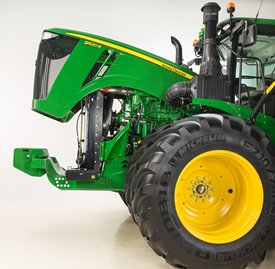 9R, 9RT, and 9RX one-piece hood
9R, 9RT, and 9RX one-piece hood

Regular service and maintenance are essential to the performance, productivity, and longevity of all farm machinery.
Maximum uptime is an important element of productivity.
- 9 Family service points are quick and simple to check.
- Greater accessibility improves serviceability.
All items in the daily service schedule can be performed without the use of tools:
- Engine oil, hydraulic oil, coolant level, and water separator can be conveniently accessed from ground level without having to open the hood.
- Engine can be easily accessed by simply raising the one-piece hood for more periodic maintenance checks.
- Single-point latch mechanism ensures easy hood opening and closure.
NOTE: Always refer to the operator’s manual for complete maintenance and service recommendations.
Typical maintenance and service information includes:
Refueling
 Fuel tank on the 9R
Fuel tank on the 9R
 Refueling
Refueling
The 9R Series Tractors fuel tank is located over the rear axle. The fuel tank features a dual fill design. This design allows the machine to be filled from either side of the fuel tank. A fuel nozzle holder is located on the gudgeon platform when the operator positions themselves on the gudgeon platform to fill the fuel tank.
The diesel exhaust fluid (DEF) tank is located on the left-hand side of the tractor indicated by a blue cap. It is fillable from ground level and has a protective shield to keep debris out of the fill neck.
Model |
Diesel (gal./L) |
DEF (gal./L) |
9370R |
320 gal. (1211 L) |
22 gal. (83 L) |
9420R |
320 gal. (1211 L) |
22 gal. (83 L) |
9470R |
320 gal. (1211 L) |
22 gal. (83 L) |
9520R |
400 gal. (1514 L) |
22 gal. (83 L) |
9570R |
400 gal. (1514 L) |
22 gal. (83 L) |
9620R |
400 gal. (1514 L) |
22 gal. (83 L) |
 Fuel tank on the left side of 9RT
Fuel tank on the left side of 9RT

The 9RT fuel tank is located in the same position as the previous 9RT model, on the left-hand main platform.
The 9RT Series Tractors all feature a DEF tank capacity of 22 gal. (83 L). The fill location is near the diesel fill location.
Model |
Diesel (gal./L) |
DEF (gal./L) |
9470RT |
350 gal. (1324 L) |
22 gal. (83 L) |
9520RT |
350 gal. (1324 L) |
22 gal. (83 L) |
9570RT |
350 gal. (1324 L) |
22 gal. (83 L) |
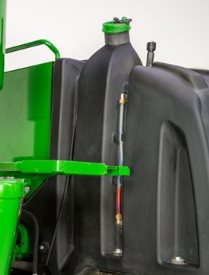
Model |
Diesel (gal./L) |
DEF (gal./L) |
9470RX |
400 gal. (1514 L) |
22 gal. (83 L) |
9520RX |
400 gal. (1514 L) |
22 gal. (83 L) |
9570RX |
400 gal. (1514 L) |
22 gal. (83 L) |
9620RX |
400 gal. (1514 L) |
22 gal. (83 L) |
NOTE:
- John Deere supports the usage of bio diesel. Bio diesel should meet ASTM D6751 (US) or EN 14214 (European) fuel quality standards.
- Tractors receive fuel containing a 2 percent bio-diesel blend at the factory
- Acceptable blend levels may vary by geographic region
- Diesel exhaust fluid will freeze when exposed for longer than three hours to conditions below -11°C (12.2° F)
For more information about the use of bio-diesel in John Deere engines, refer to www.JohnDeere.com/biodiesel
Severe-duty water separator, if equipped
The severe-duty water separator can extend service intervals and helps to protect the tractor’s fuel system from damage associated with lower-quality fuel.
Simply open the drain valve on the bottom of the separator and drain-accumulated water.
NOTE: Cummins® QSX 15L engines cannot be equipped with a severe-duty water separator; however, the fuel filter has separating capabilities like the primary filter on John Deere Power System engines.
Engine access
 Open hood on 9R
Open hood on 9R

The one-piece tilt hood design provides side shields and guards for additional engine compartment protection. The 9RT and 9RX hoods feature the same design for access to engine components.
Pull out the hood release (located on the front, left side) and tilt hood back to open.
Transmission, hydraulic, and axle oil level
 Sight gauge on 9R and 9RX
Sight gauge on 9R and 9RX
 Sight gauge on 9RT
Sight gauge on 9RT
A sight glass for the transmission, hydraulic, and axle oil level is located at the back right side of the gudgeon indicating proper oil levels and an oil fill neck is located on the back right side of the gudgeon for the 9R and 9RX Series Tractor. The oil fill is located on the top of the common reservoir on the left side of the 9RT Series Tractor and a fill tube is located between the steps and engine of the tractor.
- Provides increased filter capacity compared to previous 9R and 9RT Series Tractors
- Transmission, hydraulic, and axle oil should be changed every 1500 hours
- Filter should be changed every 1500 hours unless filter restriction code occurs
- Daily and 10-hour inspections of the transmission hydraulic oil level are recommended
NOTE: The tractor should be off and parked on level ground with the hitch in the lowered position when checking the oil level.
- Sight glass observations will be significantly higher with hot oil temperatures and lower with cold oil or if engine has not run long enough.
NOTE: Oil level above the top mark on the sight glass can result in power loss and heat generation during transport applications.
Primary air filter access
 Primary engine air filter inspection
Primary engine air filter inspection

On the 9R and 9RX, the primary engine air filter is accessible from the left-hand platform for replacement annually or as operating conditions require. The filter is aspirated and extends filter life in dusty conditions by aspirating more than 95 percent of incoming dust. Aspirator suction is created by utilizing the air flow from the cooling fan.
On the 9RT, the primary engine air filter is located at ground level on right side of tractor.
Oil change intervals
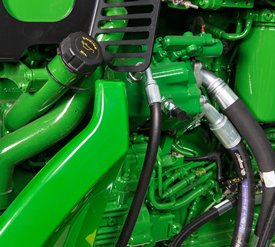 Engine oil check/fill location
Engine oil check/fill location
 Oil change
Oil change
Tractors with the 9.0 L and 13.5 L John Deere Power Systems engine features a 500-hour change interval when using approved John Deere Plus-50™ II oil and John Deere oil filter.
Tractors equipped with the Cummins® QSX 15L engine have a 400-hour engine oil and oil filter change interval.
- Previous initial oil and filter change at 100 hours is no longer required due to the factory oil fill of Break-In™ Plus.
- If using anything other than John Deere Plus-50™ II oil, a 250-hour change interval is required. CJ-4 must still be used.
- Only use ultra-low sulfur diesel fuel and CJ-4, ACEA E9, or ACEA E6 oil
- An oil change of 500 hours is possible when using fuel with less than 15 parts per million (ppm) of sulfur, along with John Deere Plus-50 II oil.
See the tractor's operator's manual for oil change intervals and further details.
Cummins is a trademark of Cummins Incorporated.
Battery access
 Battery location on 9R and 9RX
Battery location on 9R and 9RX
 Battery location on 9RT
Battery location on 9RT
The 9R and 9RX battery location is behind the left-hand step assembly. There are three bolts that secure the swinging step assembly that need to be removed to completely access the batteries. The 9RT top step of the platform conceals the tractor’s three 12-V batteries 2775 (3-925CCA). Tractors with the Cummins® QSX15 engine will have four 12-V batteries in the same location as tractors equipped with John Deere Power System engines.
Although the batteries are maintenance free, conditions such as long periods of operation at high ambient temperatures and excessive engine cranking may require adding water.
Battery boost terminal
 Battery boost terminal
Battery boost terminal

On the 9R and 9RX, a battery boost terminal is located on the left-hand side of the engine for convenient and proper boost assisted starting.
Fuse and relay panel
 Fuse and relay panel
Fuse and relay panel

The electrical fuse and relay panel is located behind the operator’s seat and just below the cab's rear window. Simply lift up on the operator manual cover for access.
- Contains easy-to-replace automotive blade-type fuses and relays for quick servicing.
- Spare fuses are provided for each amperage size used.
The diode module contains many of the diodes contained in the system:
- If a diode problem occurs, simply replace the diode module for easy service and increased uptime.
- Relays are also fully interchangeable for quick service.
Electrical system (smart load center)
The electrical system provides a full CAN-bus based system on the tractor for improved tractor implement integration and flexibility. Incorporated with the system is a smart load center which provides fewer fuses, fewer connectors, and simplified wiring for increased reliability.
The solid-state load center’s primary function is to control the majority of high-current loads, such as fender floodlights and the horn. This electronic circuitry will monitor loads and voltages to provide fast reaction time and the ability to alert the operator if a circuit overloads or if voltage is out of specification, for example open circuit (undercurrent) or short circuit (overcurrent).
Cab air filters
 Cab fresh air filter inspection
Cab fresh air filter inspection
 Cab recirculation filter
Cab recirculation filter
The cab fresh air filter is conveniently located beneath the left side of the cab for all 9 Family products:
- External service means no mess in the cab from dusty filters
- Filter housing acts as a dust accumulator compartment
- Hand screw eliminates need for tools
- Replace cab fresh air filter every 1000 hours or sooner if plugged or damaged
Cab air recirculation filter
Cab air recirculation filter is located in the roof liner above the operator. 70 percent of the total air volume is recirculated with a blanket effect for enhanced operator comfort.
- Replace cab air recirculation filter every 1000 hours or sooner if plugged or damaged.
Cab air filters are not designed to filter out harmful chemicals. Follow the instructions in the implement operator’s manual and those given by the chemical manufacturer when using agricultural chemicals.
Windshield washer
 Windshield washer bottle on 9R and 9RX
Windshield washer bottle on 9R and 9RX

The windshield washer bottle is optional on 9R and 9RX Tractors and is located on the left side of the tractor near the DEF fill point. On 9RT Tractors it is located on the right-side frame.
Maintenance-free U-joint
Maintenance-free U-joint bearings require no servicing to reduce maintenance time.
Toolbox
 Toolbox for 9R, 9RT and 9RX
Toolbox for 9R, 9RT and 9RX

A convenient toolbox is located on the left-hand side of the front frame for tool storage and comes standard on all 9R, 9RT, and 9RX Series Tractors.
9R and 9RX Series Tractors have an additional storage box conveniently located on top the left-hand platform.
The 9RT has an additional toolbox is conveniently located next to the left side of the batteries for additional storage.
Cummins is a trademark of Cummins Incorporated.
3-point hitch and CommandCenter™ controls boost productivity
3-point hitch
 3-point hitch on 9R
3-point hitch on 9R

The 9 Family Tractors are designed to maximize performance for different applications. The 9R, 9RT, and 9RX Series Tractors offer two different hitch options:
9370R |
9420R |
9470R/9470RT/9470RX |
9520R/9520RT/9520RX |
9570R/9570RT/9570RX |
9620R/9620RX |
|
Category 4N/3 with quik-coupler, all axle diameters |
Optional – 6804 kg (15,000 lb) |
Not available |
||||
Category 4N/3 with quick coupler 120-mm(4.7-in.) axles required |
Optional – 9072 kg (20,000 lb) |
Not available |
||||
Category 4/4N with quik-coupler, all diameters axles |
Optional: 6804 kg (15,000 lb) |
|||||
Category 4/4N with quik-coupler, 120-mm (4.7-in.) axle required |
Optional: 9072 kg (20,000 lb) |
|||||
CommandARM™ controls
 Hitch controls
Hitch controls
 3–point hitch controls under armrest on CommandARM
3–point hitch controls under armrest on CommandARM
To help boost productivity, control buttons are located on the 9 Family Tractors CommmandARM to access individual hitch settings. There are three buttons — set, lock, and load depth. There is also a rotary encoder that allows for finite movements of the hitch. The rotary encoder is detented so it clicks for each movement Also, located under the CommandARM are hitch adjustment controls for raise/lower rate.
Hitch load depth
The load depth feature is a useful tool designed to increase performance in tillage applications. Load depth adjustments allow the operator to make adjustments to hitch draft responsiveness.
Draft control helps maintain the operating depth in varying conditions such as rolling terrain and varying soil densities.
An additional feature with load depth control is the hitch slip option. Hitch slip uses wheel slip data to supplement the draft control system. If the wheels slip, the 3-point hitch lifts to allow the tractor wheels to maintain traction with the ground. Once the slip condition is no longer present, the hitch lowers to the required depth as determined by the hitch command and load depth settings.
Both of these hitch command options are easily programmable in the CommandCenter display by pressing the load depth shortcut key, followed by simply using the thumbwheel and confirm key to dial in the desired settings.
Hitch, external remote control switch
 3-point hitch switch on fender of 9R
3-point hitch switch on fender of 9R

For added operator convenience, a 3-point hitch remote control switch is located on top of the left rear fender for 9R, 9RT, and 9RX Tractors. The external remote switches enable the operator to raise and lower the 3-point hitch from behind the tractor while hooking to implements.
JDLink™ services and Service ADVISOR™ diagnostic systems
JDLink, Service ADVISOR, and Service ADVISOR Remote
 JDLink dashboard
JDLink dashboard

JDLink is the John Deere telematics system designed for operators and managers who desire to take their operations to the next level of productivity and efficiency without leaving the office. Whether it is receiving an e-mail or text message, users can manage the operation in real-time without being in the cab. Using the power of JDLink can optimize productivity, increase uptime, and boost profits with JDLink information all accessible from a laptop, desktop, or mobile device.
JDLink Ultimate provides enhanced machine performance and utilization information that can only be achieved through direct communication with on-board machine controllers. Utilizing John Deere-exclusive telematics technology, users can remotely link to Ultimate-compatible machines to achieve a new level of optimization.
NOTE: Mobile device compatibility and functionality varies.
Monitor assets, performance, and more with JDLink:
- Increase uptime and reduce time spent managing equipment with JDLink Ultimate
- Coordinate machine and labor logistics
- Unleash new possibilities with wireless machine connectivity
- Locate machines on-the-go with the iPhone®, iPad® or Android™ devices JDLink app
- Leverage common components from the JDLink system to enable remote support and machine monitoring
- Industry exclusive Service ADVISOR™ Remote with JDLink
For more information on JDLink activations and subscriptions visit www.StellarSupport.com
NOTE: JDLink is not available in all geographic regions.
Service ADVISOR
 Service ADVISOR
Service ADVISOR

Service ADVISOR diagnostics greatly assist in reducing service costs and downtime. It allows the John Deere service technician to readily extract vital information about tractor malfunctions through the Service ADVISOR data port. Diagnostic codes and CAN bus statistics stored by the tractor and visible in the CommandCenter™ control unit are used by service technicians to isolate, identify, and resolve problems.
Diagnostics and CAN bus statistics are not normally used by the operator. Access and use of trouble codes should only be done by a qualified, factory-trained John Deere service technician.
Service ADVISOR Remote
Service ADVISOR Remote takes the machine connectivity of JDLink and takes it one step further. With Service ADVISOR Remote, machines can be diagnosed remotely, saving the cost of a field service call. For example, diagnostic trouble codes can be reset and software updates can be uploaded remotely.
Apple, iPhone, and iPad are trademarks of Apple Inc. Android is a trademark of Google Inc.
Power take-off (PTO), 1-3/4 1000 rpm
 PTO and shield
PTO and shield

Fully independent 1000-rpm PTO is available as a factory- or field-installed option.
- Available on all 9 Family Ag Tractors.
- Full-power capability for maximum utilization*
- 4.45-cm (1-3/4-in.) diameter shaft.
* 9 Family Tractors derate PTO hp when tractor is stationary.
9R – When the PTO is on and ground speed is 0.5km/h (0.31 mph) or less; PTO is limited to 335 hp.
9RT – When the PTO is on and ground speed is 0.5km/h (0.31 mph) or less; PTO is limited to 329 hp.
9RX – When the PTO is on and ground speed is 0.5km/h (0.31 mph) or less; PTO is limited to 335 hp.
See the specs page for model rated PTO horsepower.
The PTO shield has three positions — neutral, up, and down. Use the neutral position when the PTO is connected and ready for use. Use the up position for added clearance when connecting the PTO shaft to the tractor. The down position is used when the PTO is not connected and extra visibility to the drawbar is desired.
Electrohydraulic PTO control
The 9 Family Tractors utilizes an electrohydraulic PTO-engagement switch to activate the optional 1000-rpm PTO.
If PTO option is not installed, a storage compartment is located on the rear of the tractor.
 Rear storage compartment on 9R
Rear storage compartment on 9R
e18™ PowerShift™ transmission (PST) with Efficiency Manager™ feature
The e18 transmission delivers smooth shifting and intuitive controls in a reliable 18-speed PST transmission. The e18 transmission with enhanced Efficiency Manager is standard equipment on all 9 Family Tractors.
The e18 has evolved from more than 50 years of John Deere PowerShift technology. With more automatic features, the e18 is easy to operate for all levels of operators and operations. It features three modes of operation, full AUTO, custom, and manual modes. Full AUTO and custom modes manage the engine and transmission to match the desired ground speed to the field conditions. These two modes are ideal for most conditions and take the guess work out of operation. Manual mode is perfect for operators looking to operate the e18 like a traditional PowerShift by bump shifting and managing the engine throttle to their liking.
As the next generation of PowerShift technology, the e18 delivers the strength to handle sudden, high-torque power loads while maintaining responsive, quick, and smooth shifts.
e18 controls
 Shift lever and hand throttle
Shift lever and hand throttle

CommandCenter™ controls
 254-mm (10-in.) Generation 4 CommandCenter
254-mm (10-in.) Generation 4 CommandCenter

The CommandCenter is the central information system for tractors and allows the operator to program various settings tailored to a specific operation.
To access the tractor’s transmission settings, press the transmission shortcut button on the CommandCenter shortcut bar.
 CommandCenter transmission shortcut button
CommandCenter transmission shortcut button

Operating modes
The e18 application settings employ three modes to take full advantage of the engine-transmission communication: Full AUTO mode, custom mode, and manual mode.
Full AUTO mode
 Full AUTO main page
Full AUTO main page

Full AUTO mode manages the tractor’s engine and transmission inputs to reach and maintain the desired ground speed set by the operator. This means the tractor will manage shifts and engine rpm to operate at the most efficient level possible. Operators have the ability to set the maximum forward and reverse speeds for their particular applications. In full AUTO mode the operator can adjust the desired ground speed in two ways, by conducting a traditional bump shift or by rotating the dial on the thumb wheel.
When shifting in full AUTO mode, the transmission shifts set speeds and does not always shift gears, meaning the transmission may not necessarily shift gears if it can reach the desired ground speed with a slightly higher or lower engine rpm. Efficiency Manager is automatically engaged while operating in full AUTO mode. As a result, shifting will not take the tractor out of Efficiency Manager in full AUTO mode.
Custom mode
 e18 custom transmission page
e18 custom transmission page

Custom mode operates similar to full AUTO mode but allows operators to adjust operating parameters to meet a specific operation. It also has the ability to activate eco mode for a higher level of operation.
 Eco button
Eco button
 Display screen
Display screen
Eco allows two minimum engine speeds to be set. Operators can turn eco on and off by either pushing the eco button on the side of the throttle or by selecting eco in the transmission settings page of the CommandCenter controls. For example, operators may choose to turn eco on during transport to utilize a lower minimum engine speed and then turn eco off while operating in the field where a higher minimum engine speed is desired.
 Custom settings page
Custom settings page

In the advanced settings page, operators can customize the auto shift engine speed droop as a percentage of the full engine speed. In addition, the load anticipation feature can be enabled for the hitch engagement, hydraulic engagement, or both.
Manual mode
Manual mode operates very similarly to a traditional PowerShift transmission with Efficiency Manager.
In manual mode the operator manages the engine and transmission inputs by controlling the shift lever and hand throttle.
 Manual mode page
Manual mode page

Efficiency Manager
 Set speed buttons and set speed adjuster
Set speed buttons and set speed adjuster

Efficiency Manager is automatically enabled in auto and custom modes. Efficiency Manager can be turned on in manual mode by selecting the set speed one or set speed two button on the CommandARM™ console. The set speed adjuster on the top of the single-lever gear selector allows the operator to dial in the desired ground speed to establish set speed one or two. Once engaged, Efficiency Manager will manage the engine rpm and gear selection to maintain the desired working speed. To reach the desired set speed, the throttle must be set to full engine rpm.
e18 operation
 e18 operation
e18 operation

Setting start-up gears
The 9 Family Tractors default to 7F and 2R at start up. However, these default start-up gears can be adjusted from 1-13F and 1-3R through the CommandCenter. Refer to the operator’s manual for additional information.
 Start-up gears in advanced settings
Start-up gears in advanced settings

9R Series Tractor - e18-speed chart for PowerShift transmission (PST) with Efficiency Manager
9R table
Group 47 tires |
Group 48 tires |
|||
Tire size |
(480R46, 20.8R42, 520R42, 620R42, 710R38) |
(480R50, 520R46, 620R46, 710R42, 800R38) |
||
Engine (rpm) |
2100 |
2100 |
||
18-speed gear |
km/h |
mph |
km/h |
mph |
Forward gears |
||||
F1 |
4.0 |
2.5 |
4.2 |
2.6 |
F2 |
4.8 |
3.0 |
5.0 |
3.1 |
F3 |
5.3 |
3.3 |
5.6 |
3.5 |
F4 |
5.9 |
3.7 |
6.2 |
3.9 |
F5 |
6.5 |
4.0 |
6.8 |
4.3 |
F6 |
7.3 |
4.5 |
7.6 |
4.8 |
F7 |
8.0 |
5.0 |
8.5 |
5.3 |
F8 |
9.0 |
5.6 |
9.5 |
5.9 |
F9 |
9.9 |
6.1 |
10.4 |
6.5 |
F10 |
11.0 |
6.9 |
11.6 |
7.2 |
F11 |
12.2 |
7.6 |
12.9 |
8.0 |
F12 |
13.5 |
8.4 |
14.2 |
8.8 |
F13 |
15.0 |
9.3 |
15.8 |
9.8 |
F14 |
16.6 |
10.3 |
17.5 |
10.9 |
F15 |
20.5 |
12.8 |
21.6 |
13.4 |
F16 |
25.3 |
15.7 |
26.6 |
16.5 |
F17 |
31.2 |
19.4 |
32.9 |
20.4 |
F18 |
38.5 |
23.9 |
40.5 |
25.2 |
Reverse gears |
||||
R1 |
3.9 |
2.4 |
4.1 |
2.5 |
R2 |
5.3 |
3.3 |
5.6 |
3.5 |
R3 |
5.9 |
3.7 |
6.2 |
3.9 |
R4 |
8.0 |
5.0 |
8.5 |
5.3 |
R5 |
9.0 |
5.6 |
9.5 |
5.9 |
R6 |
12.2 |
7.6 |
12.9 |
8.0 |
Group 47 tire based on 710/70R38
Group 48 tire based on 800/80R38
9RT and 9RX Series Tractor - e18-speed chart for PowerShift transmission (PST) with Efficiency Manager
9RT and 9RX table
|
9RT |
9RX |
||
Engine (rpm) |
2100 |
2100 |
||
18-speed gear |
km/h |
mph |
km/h |
mph |
Forward gears |
|
|
|
|
F1 |
4.0 |
2.5 |
4.0 |
2.5 |
F2 |
5.0 |
3.1 |
4.9 |
3.0 |
F3 |
5.5 |
3.4 |
5.5 |
3.4 |
F4 |
6.1 |
3.8 |
6.1 |
3.8 |
F5 |
6.8 |
4.2 |
6.7 |
4.2 |
F6 |
7.6 |
4.7 |
7.5 |
4.7 |
F7 |
8.4 |
5.2 |
8.3 |
5.2 |
F8 |
9.3 |
5.8 |
9.2 |
5.7 |
F9 |
10.3 |
6.4 |
10.2 |
6.3 |
F10 |
11.4 |
7.1 |
11.4 |
7.1 |
F11 |
12.6 |
7.8 |
12.6 |
7.8 |
F12 |
14.1 |
8.7 |
14.0 |
8.7 |
F13 |
15.6 |
9.7 |
15.5 |
9.6 |
F14 |
17.3 |
10.7 |
17.2 |
10.3 |
F15 |
21.4 |
13.3 |
21.3 |
13.2 |
F16 |
26.3 |
16.3 |
26.2 |
16.3 |
F17 |
32.3 |
20.1 |
32.2 |
20.0 |
F18 |
39.8 |
24.7 |
39.6 |
24.6 |
Reverse gears |
|
|
|
|
R1 |
4.0 |
2.5 |
4.0 |
2.5 |
R2 |
5.5 |
3.4 |
5.5 |
3.4 |
R3 |
6.1 |
3.3 |
6.1 |
3.8 |
R4 |
7.3 |
3.8 |
8.3 |
5.2 |
R5 |
9.3 |
5.8 |
9.2 |
5.7 |
R6 |
12.6 |
7.8 |
12.6 |
10.3 |
High-flow hydraulics, 435 L/min (115 gpm) system
Dual hydraulic pump system
 Selective control valve (SCV) stack
Selective control valve (SCV) stack

Optional high-flow hydraulics are available on 9 Family Tractors by ordering code 3270. The high-flow hydraulic system provides an additional 215 L/ min (57 gpm) of flow for a total of 435 L/ min (115 gpm). This system is ideal for hydraulic fan motor demands. This system is recommended for agricultural implements with continuous flow requirements. When maximum hydraulic pump capacity is reached, multiple functions will continue to operate at the same proportional flow rate.
The 9 Family Ag High-Flow Tractors have two parallel hydraulic systems. The benefit of this system is that functions can be split between the two systems. Functions that require high flow and low pressure can be combined on one system (for example, air seeder fans, and planter motors). Functions that require high pressure and low-flow can be connected to the remaining system (for example, implement lift, fold, and constant down-pressure systems).
Following these guidelines allows the hydraulic system to run cooler as it prevents both hydraulic pumps from running at high pressure. In general, pumps forced to run at both high pressure and high flows generate much more heat than a pump running at a lower flow or lower pressure.
The system operates with two hydraulic pumps:
- Pump 1 - provides hydraulic flow of up to 215 L/min (58 gpm) to SCVs 1, 2, and 3. These SCVs are useful for operating lift/lower and other cylinder type hydraulic needs.
- Pump 2 - attaches in front of pump 1 and provides hydraulic flow of up to 215 L/min (57 gpm) to SCVs 4, 5, and 6. These SCVs are useful for operating hydraulic motors to drive air/fan or vacuum systems on seeding/planting equipment.
- All SCV oil returns to one common hydraulic reservoir.

